LIVRES - - EBOOKS - THEME : SCIENCE
LIVRES - - EBOOKS - THEME : SCIENCe
IMAGE_LINK LINK TITLE DESCRIPTION PRODUCT_TYPE

Practical Biostatistics Evidence-based medicine aims to apply the best available evidence gained from the scientific method to medical decision making. It is a practice that uses statistical analysis of scientific methods and outcomes to drive further experimentation and diagnosis. The profusion of evidence-based medicine in medical practice and clinical research has produced a need for life scientists and clinical researchers to assimilate biostatistics into their work to meet efficacy and practical standards. Practical Biostatistics provides researchers, medical professionals, and students with a friendly, practical guide to biostatistics. With a detailed outline of implementation steps complemented by a review of important topics, this book can be used as a quick reference or a hands-on guide to effectively incorporate biostatistics in clinical trials. Customized presentation for biological investigators with examples taken from current clinical trials in multiple disciplines Clear and concise definitions and examples provide a pragmatic guide to bring clarity to the applications of statistics in improving human health Addresses the challenge of assimilation of mathematical concepts to better interpret literature, to build stronger studies, to present research effectively, and to improve communication with supporting biostatisticians COMPUTERS,Data Science,Bioinformatics

Bioinformatics Data Skills Learn the data skills necessary for turning large sequencing datasets into reproducible and robust biological findings. With this practical guide, you’ll learn how to use freely available open source tools to extract meaning from large complex biological data sets. At no other point in human history has our ability to understand life’s complexities been so dependent on our skills to work with and analyze data. This intermediate-level book teaches the general computational and data skills you need to analyze biological data. If you have experience with a scripting language like Python, you’re ready to get started. Go from handling small problems with messy scripts to tackling large problems with clever methods and tools Process bioinformatics data with powerful Unix pipelines and data tools Learn how to use exploratory data analysis techniques in the R language Use efficient methods to work with genomic range data and range operations Work with common genomics data file formats like FASTA, FASTQ, SAM, and BAM Manage your bioinformatics project with the Git version control system Tackle tedious data processing tasks with with Bash scripts and Makefiles COMPUTERS,Data Science,Bioinformatics

Gentle Introduction To Support Vector Machines In Biomedicine, A - Volume 1 Support Vector Machines (SVMs) are among the most important recent developments in pattern recognition and statistical machine learning. They have found a great range of applications in various fields including biology and medicine. However, biomedical researchers often experience difficulties grasping both the theory and applications of these important methods because of lack of technical background. The purpose of this book is to introduce SVMs and their extensions and allow biomedical researchers to understand and apply them in real-life research in a very easy manner. The book is to consist of two volumes: theory and methods (Volume 1) and case studies (Volume 2). COMPUTERS,Data Science,Bioinformatics

Companion Diagnostics (CDx) in Precision Medicine There is a new trend in anti-cancer therapeutics development: a targeted therapy and precision medicine that targets a subgroup of patients with specific biomarkers. An in vitro diagnostic (IVD) assay is required to identify a subgroup of cancer patients who would benefit from the targeted therapy, or not likely benefit, or have a high risk of side effects from the specific drug treatment. This IVD or medical device is called a companion diagnostic (CDx) assay. It is key to have a robust CDx assay or device for the success of targeted therapy and precision medicine. This book covers the technical, historical, clinical, and regulatory aspects of CDx in precision medicine. Clearly, more and more newly developed oncology drugs will require accompanying CDx assays, and this book, with chapters contributed by renowned oncologists, provides a comprehensive foundation for the knowledge and application of CDx for precision medicine. COMPUTERS,Data Science,Bioinformatics

R Bioinformatics Cookbook Over 60 recipes to model and handle real-life biological data using modern libraries from the R ecosystem Key Features Apply modern R packages to handle biological data using real-world examples Represent biological data with advanced visualizations suitable for research and publications Handle real-world problems in bioinformatics such as next-generation sequencing, metagenomics, and automating analyses Book Description Handling biological data effectively requires an in-depth knowledge of machine learning techniques and computational skills, along with an understanding of how to use tools such as edgeR and DESeq. With the R Bioinformatics Cookbook, you'll explore all this and more, tackling common and not-so-common challenges in the bioinformatics domain using real-world examples. This book will use a recipe-based approach to show you how to perform practical research and analysis in computational biology with R. You will learn how to effectively analyze your data with the latest tools in Bioconductor, ggplot, and tidyverse. The book will guide you through the essential tools in Bioconductor to help you understand and carry out protocols in RNAseq, phylogenetics, genomics, and sequence analysis. As you progress, you will get up to speed with how machine learning techniques can be used in the bioinformatics domain. You will gradually develop key computational skills such as creating reusable workflows in R Markdown and packages for code reuse. By the end of this book, you'll have gained a solid understanding of the most important and widely used techniques in bioinformatic analysis and the tools you need to work with real biological data. What you will learn Employ Bioconductor to determine differential expressions in RNAseq data Run SAMtools and develop pipelines to find single nucleotide polymorphisms (SNPs) and Indels Use ggplot to create and annotate a range of visualizations Query external databases with Ensembl to find functional genomics information Execute large-scale multiple sequence alignment with DECIPHER to perform comparative genomics Use d3.js and Plotly to create dynamic and interactive web graphics Use k-nearest neighbors, support vector machines and random forests to find groups and classify data Who this book is for This book is for bioinformaticians, data analysts, researchers, and R developers who want to address intermediate-to-advanced biological and bioinformatics problems by learning through a recipe-based approach. Working knowledge of R programming language and basic knowledge of bioinformatics are prerequisites. COMPUTERS,Data Science,Bioinformatics

Genomics in the Cloud Data in the genomics field is booming. In just a few years, organizations such as the National Institutes of Health (NIH) will host 50+ petabytes—or over 50 million gigabytes—of genomic data, and they’re turning to cloud infrastructure to make that data available to the research community. How do you adapt analysis tools and protocols to access and analyze that volume of data in the cloud? With this practical book, researchers will learn how to work with genomics algorithms using open source tools including the Genome Analysis Toolkit (GATK), Docker, WDL, and Terra. Geraldine Van der Auwera, longtime custodian of the GATK user community, and Brian O’Connor of the UC Santa Cruz Genomics Institute, guide you through the process. You’ll learn by working with real data and genomics algorithms from the field. This book covers: Essential genomics and computing technology background Basic cloud computing operations Getting started with GATK, plus three major GATK Best Practices pipelines Automating analysis with scripted workflows using WDL and Cromwell Scaling up workflow execution in the cloud, including parallelization and cost optimization Interactive analysis in the cloud using Jupyter notebooks Secure collaboration and computational reproducibility using Terra COMPUTERS,Data Science,Bioinformatics

Biological Language Model Conceived as a cross between natural language processing methods and biological sequences in DNA, RNA and protein, biological language model is a new scientific research topic in bioinformatics that has been extensively studied by the authors. The basic theory and applications of this model are presented in this book to serve as an reference for graduate students and researchers. COMPUTERS,Data Science,Bioinformatics

Statistical Approaches to Gene x Environment Interactions for Complex Phenotypes Diverse methodological and statistical approaches for investigating the role of gene-environment interactions in a range of complex diseases and traits. Findings from the Human Genome Project and from Genome-Wide Association (GWA) studies indicate that many diseases and traits manifest a more complex genomic pattern than previously assumed. These findings, and advances in high-throughput sequencing, suggest that there are many sources of influence—genetic, epigenetic, and environmental. This volume investigates the role of the interactions of genes and environment (G × E) in diseases and traits (referred to by the contributors as complex phenotypes) including depression, diabetes, obesity, and substance use. The contributors first present different statistical approaches or strategies to address G × E and G × G interactions with high-throughput sequenced data, including two-stage procedures to identify G × E and G × G interactions, marker-set approaches to assessing interactions at the gene level, and the use of a partial-least square (PLS) approach. The contributors then turn to specific complex phenotypes, research designs, or combined methods that may advance the study of G × E interactions, considering such topics as randomized clinical trials in obesity research, longitudinal research designs and statistical models, and the development of polygenic scores to investigate G × E interactions. Contributors Fatima Umber Ahmed, Yin-Hsiu Chen, James Y. Dai, Caroline Y. Doyle, Zihuai He, Li Hsu, Shuo Jiao, Erin Loraine Kinnally, Yi-An Ko, Charles Kooperberg, Seunggeun Lee, Arnab Maity, Jeanne M. McCaffery, Bhramar Mukherjee, Sung Kyun Park, Duncan C. Thomas, Alexandre Todorov, Jung-Ying Tzeng, Tao Wang, Michael Windle, Min Zhang COMPUTERS,Data Science,Bioinformatics

Building Ontologies with Basic Formal Ontology An introduction to the field of applied ontology with examples derived particularly from biomedicine, covering theoretical components, design practices, and practical applications. In the era of “big data,” science is increasingly information driven, and the potential for computers to store, manage, and integrate massive amounts of data has given rise to such new disciplinary fields as biomedical informatics. Applied ontology offers a strategy for the organization of scientific information in computer-tractable form, drawing on concepts not only from computer and information science but also from linguistics, logic, and philosophy. This book provides an introduction to the field of applied ontology that is of particular relevance to biomedicine, covering theoretical components of ontologies, best practices for ontology design, and examples of biomedical ontologies in use. After defining an ontology as a representation of the types of entities in a given domain, the book distinguishes between different kinds of ontologies and taxonomies, and shows how applied ontology draws on more traditional ideas from metaphysics. It presents the core features of the Basic Formal Ontology (BFO), now used by over one hundred ontology projects around the world, and offers examples of domain ontologies that utilize BFO. The book also describes Web Ontology Language (OWL), a common framework for Semantic Web technologies. Throughout, the book provides concrete recommendations for the design and construction of domain ontologies. COMPUTERS,Data Science,Bioinformatics

FileMaker Pro 8 Used by millions worldwide, FileMaker Pro is an award-winning database program for managing people, projects, images, assets, and other information. It's easy to use and totally customizable--so long as you know what you're doing. But FileMaker Pro doesn't come with a printed manual, so FileMaker Pro: The Missing Manual is the authoritative, jargon-free book that should have been in the box. FileMaker Pro: The Missing Manual approaches FileMaker the way FileMaker approaches you: it's user-friendly and seemingly straightforward enough, but it offers plenty of substance worthy of deeper exploration. Packed with practical information as well as countless expert tips and invaluable guidance, it's an in-depth guide to designing and building useful databases with the powerful and pliable FileMaker Pro. Covering FileMaker for both Windows and Macintosh, FileMaker Pro: The Missing Manual is ideal for small business users, home users, school teachers, developers--anyone who wants to organize information efficiently and effectively. Whether you want to run a business, publish a shopping cart on the Web, plan a wedding, manage a student information system at your school, or program databases for clients, this book delivers. Author Geoff Coffey has many years of experience using FileMaker Pro (he was, in fact, an early beta tester for the product). Author Susan Prosser is a FileMaker Certified Developer who trains other developers. Together, Coffey and Prosser show you how to: Get FileMaker up and running quickly and smoothly Import and organize information with ease Design relational databases that are simple to use, yet powerful Take advantage of FileMaker Pro calculation capabilities Automate processes with scripting Customize FileMaker Pro to your needs and preferences Share information with other people (coworkers, clients, and customers) and other programs Understand and select the best security options What could easily come across as dry and intimidating--things like relational theory, calculations, and scripting--are presented in a way that is interesting and intuitive to mainstream users. In no time, you'll be working more productively and efficiently using FileMaker Pro. COMPUTERS,Data Science,Data Analytics

Practical PostgreSQL Arguably the most capable of all the open source databases, PostgreSQL is an object-relational database management system first developed in 1977 by the University of California at Berkeley. In spite of its long history, this robust database suffers from a lack of easy-to-use documentation. Practical PostgreSQL fills that void with a fast-paced guide to installation, configuration, and usage. This comprehensive new volume shows you how to compile PostgreSQL from source, create a database, and configure PostgreSQL to accept client-server connections. It also covers the many advanced features, such as transactions, versioning, replication, and referential integrity that enable developers and DBAs to use PostgreSQL for serious business applications. The thorough introduction to PostgreSQL's PL/pgSQL programming language explains how you can use this very useful but under-documented feature to develop stored procedures and triggers. The book includes a complete command reference, and database administrators will appreciate the chapters on user management, database maintenance, and backup & recovery. With Practical PostgreSQL, you will discover quickly why this open source database is such a great open source alternative to proprietary products from Oracle, IBM, and Microsoft. COMPUTERS,Data Science,Data Analytics

High Performance MySQL How can you bring out MySQL’s full power? With High Performance MySQL, you’ll learn advanced techniques for everything from designing schemas, indexes, and queries to tuning your MySQL server, operating system, and hardware to their fullest potential. This guide also teaches you safe and practical ways to scale applications through replication, load balancing, high availability, and failover. Updated to reflect recent advances in MySQL and InnoDB performance, features, and tools, this third edition not only offers specific examples of how MySQL works, it also teaches you why this system works as it does, with illustrative stories and case studies that demonstrate MySQL’s principles in action. With this book, you’ll learn how to think in MySQL. Learn the effects of new features in MySQL 5.5, including stored procedures, partitioned databases, triggers, and views Implement improvements in replication, high availability, and clustering Achieve high performance when running MySQL in the cloud Optimize advanced querying features, such as full-text searches Take advantage of modern multi-core CPUs and solid-state disks Explore backup and recovery strategies—including new tools for hot online backups COMPUTERS,Data Science,Data Analytics

Marketing Analytics Helping tech-savvy marketers and data analysts solve real-world business problems with Excel Using data-driven business analytics to understand customers and improve results is a great idea in theory, but in today's busy offices, marketers and analysts need simple, low-cost ways to process and make the most of all that data. This expert book offers the perfect solution. Written by data analysis expert Wayne L. Winston, this practical resource shows you how to tap a simple and cost-effective tool, Microsoft Excel, to solve specific business problems using powerful analytic techniques—and achieve optimum results. Practical exercises in each chapter help you apply and reinforce techniques as you learn. Shows you how to perform sophisticated business analyses using the cost-effective and widely available Microsoft Excel instead of expensive, proprietary analytical tools Reveals how to target and retain profitable customers and avoid high-risk customers Helps you forecast sales and improve response rates for marketing campaigns Explores how to optimize price points for products and services, optimize store layouts, and improve online advertising Covers social media, viral marketing, and how to exploit both effectively Improve your marketing results with Microsoft Excel and the invaluable techniques and ideas in Marketing Analytics: Data-Driven Techniques with Microsoft Excel. COMPUTERS,Data Science,Data Analytics

Business Analytics Principles, Concepts, and Applications Learn everything you need to know to start using business analytics and integrating it throughout your organization. Business Analytics Principles, Concepts, and Applications brings together a complete, integrated package of knowledge for newcomers to the subject. The authors present an up-to-date view of what business analytics is, why it is so valuable, and most importantly, how it is used. They combine essential conceptual content with clear explanations of the tools, techniques, and methodologies actually used to implement modern business analytics initiatives. They offer a proven step-wise approach to designing an analytics program, and successfully integrating it into your organization, so it effectively provides intelligence for competitive advantage in decision making. Using step-by-step examples, the authors identify common challenges that can be addressed by business analytics, illustrate each type of analytics (descriptive, prescriptive, and predictive), and guide users in undertaking their own projects. Illustrating the real-world use of statistical, information systems, and management science methodologies, these examples help readers successfully apply the methods they are learning. Unlike most competitive guides, this text demonstrates the use of IBM's menu-based SPSS software, permitting instructors to spend less time teaching software and more time focusing on business analytics itself. A valuable resource for all beginning-to-intermediate-level business analysts and business analytics managers; for MBA/Masters' degree students in the field; and for advanced undergraduates majoring in statistics, applied mathematics, or engineering/operations research. COMPUTERS,Data Science,Data Analytics

Data Mining With Decision Trees Decision trees have become one of the most powerful and popular approaches in knowledge discovery and data mining; it is the science of exploring large and complex bodies of data in order to discover useful patterns. Decision tree learning continues to evolve over time. Existing methods are constantly being improved and new methods introduced.This 2nd Edition is dedicated entirely to the field of decision trees in data mining; to cover all aspects of this important technique, as well as improved or new methods and techniques developed after the publication of our first edition. In this new edition, all chapters have been revised and new topics brought in. New topics include Cost-Sensitive Active Learning, Learning with Uncertain and Imbalanced Data, Using Decision Trees beyond Classification Tasks, Privacy Preserving Decision Tree Learning, Lessons Learned from Comparative Studies, and Learning Decision Trees for Big Data. A walk-through guide to existing open-source data mining software is also included in this edition.This book invites readers to explore the many benefits in data mining that decision trees offer: COMPUTERS,Data Science,Data Analytics

Statistics for Big Data For Dummies The fast and easy way to make sense of statistics for big data Does the subject of data analysis make you dizzy? You've come to the right place! Statistics For Big Data For Dummies breaks this often-overwhelming subject down into easily digestible parts, offering new and aspiring data analysts the foundation they need to be successful in the field. Inside, you'll find an easy-to-follow introduction to exploratory data analysis, the lowdown on collecting, cleaning, and organizing data, everything you need to know about interpreting data using common software and programming languages, plain-English explanations of how to make sense of data in the real world, and much more. Data has never been easier to come by, and the tools students and professionals need to enter the world of big data are based on applied statistics. While the word "statistics" alone can evoke feelings of anxiety in even the most confident student or professional, it doesn't have to. Written in the familiar and friendly tone that has defined the For Dummies brand for more than twenty years, Statistics For Big Data For Dummies takes the intimidation out of the subject, offering clear explanations and tons of step-by-step instruction to help you make sense of data mining—without losing your cool. Helps you to identify valid, useful, and understandable patterns in data Provides guidance on extracting previously unknown information from large databases Shows you how to discover patterns available in big data Gives you access to the latest tools and techniques for working in big data If you're a student enrolled in a related Applied Statistics course or a professional looking to expand your skillset, Statistics For Big Data For Dummies gives you access to everything you need to succeed. COMPUTERS,Data Science,Data Analytics

Data Science and Big Data Analytics Data Science and Big Data Analytics is about harnessing the power of data for new insights. The book covers the breadth of activities and methods and tools that Data Scientists use. The content focuses on concepts, principles and practical applications that are applicable to any industry and technology environment, and the learning is supported and explained with examples that you can replicate using open-source software. This book will help you: Become a contributor on a data science team Deploy a structured lifecycle approach to data analytics problems Apply appropriate analytic techniques and tools to analyzing big data Learn how to tell a compelling story with data to drive business action Prepare for EMC Proven Professional Data Science Certification Corresponding data sets are available at www.wiley.com/go/9781118876138. Get started discovering, analyzing, visualizing, and presenting data in a meaningful way today! COMPUTERS,Data Science,Data Analytics

Fraud Analytics Using Descriptive, Predictive, and Social Network Techniques Detect fraud earlier to mitigate loss and prevent cascading damage Fraud Analytics Using Descriptive, Predictive, and Social Network Techniques is an authoritative guidebook for setting up a comprehensive fraud detection analytics solution. Early detection is a key factor in mitigating fraud damage, but it involves more specialized techniques than detecting fraud at the more advanced stages. This invaluable guide details both the theory and technical aspects of these techniques, and provides expert insight into streamlining implementation. Coverage includes data gathering, preprocessing, model building, and post-implementation, with comprehensive guidance on various learning techniques and the data types utilized by each. These techniques are effective for fraud detection across industry boundaries, including applications in insurance fraud, credit card fraud, anti-money laundering, healthcare fraud, telecommunications fraud, click fraud, tax evasion, and more, giving you a highly practical framework for fraud prevention. It is estimated that a typical organization loses about 5% of its revenue to fraud every year. More effective fraud detection is possible, and this book describes the various analytical techniques your organization must implement to put a stop to the revenue leak. Examine fraud patterns in historical data Utilize labeled, unlabeled, and networked data Detect fraud before the damage cascades Reduce losses, increase recovery, and tighten security The longer fraud is allowed to go on, the more harm it causes. It expands exponentially, sending ripples of damage throughout the organization, and becomes more and more complex to track, stop, and reverse. Fraud prevention relies on early and effective fraud detection, enabled by the techniques discussed here. Fraud Analytics Using Descriptive, Predictive, and Social Network Techniques helps you stop fraud in its tracks, and eliminate the opportunities for future occurrence. COMPUTERS,Data Science,Data Analytics

Accumulo Get up to speed on Apache Accumulo, the flexible, high-performance key/value store created by the National Security Agency (NSA) and based on Google’s BigTable data storage system. Written by former NSA team members, this comprehensive tutorial and reference covers Accumulo architecture, application development, table design, and cell-level security. With clear information on system administration, performance tuning, and best practices, this book is ideal for developers seeking to write Accumulo applications, administrators charged with installing and maintaining Accumulo, and other professionals interested in what Accumulo has to offer. You will find everything you need to use this system fully. Get a high-level introduction to Accumulo’s architecture and data model Take a rapid tour through single- and multiple-node installations, data ingest, and query Learn how to write Accumulo applications for several use cases, based on examples Dive into Accumulo internals, including information not available in the documentation Get detailed information for installing, administering, tuning, and measuring performance Learn best practices based on successful implementations in the field Find answers to common questions that every new Accumulo user asks COMPUTERS,Data Science,Data Analytics

Bayesian Methods for Hackers Master Bayesian Inference through Practical Examples and Computation–Without Advanced Mathematical Analysis Bayesian methods of inference are deeply natural and extremely powerful. However, most discussions of Bayesian inference rely on intensely complex mathematical analyses and artificial examples, making it inaccessible to anyone without a strong mathematical background. Now, though, Cameron Davidson-Pilon introduces Bayesian inference from a computational perspective, bridging theory to practice–freeing you to get results using computing power. Bayesian Methods for Hackers illuminates Bayesian inference through probabilistic programming with the powerful PyMC language and the closely related Python tools NumPy, SciPy, and Matplotlib. Using this approach, you can reach effective solutions in small increments, without extensive mathematical intervention. Davidson-Pilon begins by introducing the concepts underlying Bayesian inference, comparing it with other techniques and guiding you through building and training your first Bayesian model. Next, he introduces PyMC through a series of detailed examples and intuitive explanations that have been refined after extensive user feedback. You’ll learn how to use the Markov Chain Monte Carlo algorithm, choose appropriate sample sizes and priors, work with loss functions, and apply Bayesian inference in domains ranging from finance to marketing. Once you’ve mastered these techniques, you’ll constantly turn to this guide for the working PyMC code you need to jumpstart future projects. Coverage includes • Learning the Bayesian “state of mind†and its practical implications • Understanding how computers perform Bayesian inference • Using the PyMC Python library to program Bayesian analyses • Building and debugging models with PyMC • Testing your model’s “goodness of fit†• Opening the “black box†of the Markov Chain Monte Carlo algorithm to see how and why it works • Leveraging the power of the “Law of Large Numbers†• Mastering key concepts, such as clustering, convergence, autocorrelation, and thinning • Using loss functions to measure an estimate’s weaknesses based on your goals and desired outcomes • Selecting appropriate priors and understanding how their influence changes with dataset size • Overcoming the “exploration versus exploitation†dilemma: deciding when “pretty good†is good enough • Using Bayesian inference to improve A/B testing • Solving data science problems when only small amounts of data are available Cameron Davidson-Pilon has worked in many areas of applied mathematics, from the evolutionary dynamics of genes and diseases to stochastic modeling of financial prices. His contributions to the open source community include lifelines, an implementation of survival analysis in Python. Educated at the University of Waterloo and at the Independent University of Moscow, he currently works with the online commerce leader Shopify. COMPUTERS,Data Science,Data Analytics

Hadoop 2 Quick-Start Guide Get Started Fast with Apache Hadoop® 2, YARN, and Today’s Hadoop Ecosystem With Hadoop 2.x and YARN, Hadoop moves beyond MapReduce to become practical for virtually any type of data processing. Hadoop 2.x and the Data Lake concept represent a radical shift away from conventional approaches to data usage and storage. Hadoop 2.x installations offer unmatched scalability and breakthrough extensibility that supports new and existing Big Data analytics processing methods and models. Hadoop® 2 Quick-Start Guide is the first easy, accessible guide to Apache Hadoop 2.x, YARN, and the modern Hadoop ecosystem. Building on his unsurpassed experience teaching Hadoop and Big Data, author Douglas Eadline covers all the basics you need to know to install and use Hadoop 2 on personal computers or servers, and to navigate the powerful technologies that complement it. Eadline concisely introduces and explains every key Hadoop 2 concept, tool, and service, illustrating each with a simple “beginning-to-end†example and identifying trustworthy, up-to-date resources for learning more. This guide is ideal if you want to learn about Hadoop 2 without getting mired in technical details. Douglas Eadline will bring you up to speed quickly, whether you’re a user, admin, devops specialist, programmer, architect, analyst, or data scientist. Coverage Includes Understanding what Hadoop 2 and YARN do, and how they improve on Hadoop 1 with MapReduce Understanding Hadoop-based Data Lakes versus RDBMS Data Warehouses Installing Hadoop 2 and core services on Linux machines, virtualized sandboxes, or clusters Exploring the Hadoop Distributed File System (HDFS) Understanding the essentials of MapReduce and YARN application programming Simplifying programming and data movement with Apache Pig, Hive, Sqoop, Flume, Oozie, and HBase Observing application progress, controlling jobs, and managing workflows Managing Hadoop efficiently with Apache Ambari–including recipes for HDFS to NFSv3 gateway, HDFS snapshots, and YARN configuration Learning basic Hadoop 2 troubleshooting, and installing Apache Hue and Apache Spark COMPUTERS,Data Science,Data Analytics

Project Management Analytics To manage projects, you must not only control schedules and costs: you must also manage growing operational uncertainty. Today’s powerful analytics tools and methods can help you do all of this far more successfully. In Project Management Analytics , Harjit Singh shows how to bring greater evidence-based clarity and rationality to all your key decisions throughout the full project lifecycle. Singh identifies the components and characteristics of a good project decision and shows how to improve decisions by using predictive, prescriptive, statistical, and other methods. You’ll learn how to mitigate risks by identifying meaningful historical patterns and trends; optimize allocation and use of scarce resources within project constraints; automate data-driven decision-making processes based on huge data sets; and effectively handle multiple interrelated decision criteria. Singh also helps you integrate analytics into the project management methods you already use, combining today’s best analytical techniques with proven approaches such as PMI PMBOK® and Lean Six Sigma. Project managers can no longer rely on vague impressions or seat-of-the-pants intuition. Fortunately, you don’t have to. With Project Management Analytics , you can use facts, evidence, and knowledge—and get far better results. Achieve efficient, reliable, consistent, and fact-based project decision-making Systematically bring data and objective analysis to key project decisions Avoid “garbage in, garbage out†Properly collect, store, analyze, and interpret your project-related data Optimize multi-criteria decisions in large group environments Use the Analytic Hierarchy Process (AHP) to improve complex real-world decisions Streamline projects the way you streamline other business processes Leverage data-driven Lean Six Sigma to manage projects more effectively COMPUTERS,Data Science,Data Analytics

R in 24 Hours, Sams Teach Yourself In just 24 lessons of one hour or less, Sams Teach Yourself R in 24 Hours helps you learn all the R skills you need to solve a wide spectrum of real-world data analysis problems. You’ll master the entire data analysis workflow, learning to build code that’s efficient, reproducible, and suitable for sharing with others. This book’s straightforward, step-by-step approach teaches you how to import, manipulate, summarize, model, and plot data with R; formalize your analytical code; and build powerful R packages using current best practices. Practical, hands-on examples show you how to apply what you learn. Quizzes and exercises help you test your knowledge and stretch your skills. Learn How To Install, configure, and explore the R environment, including RStudio Use basic R syntax, objects, and packages Create and manage data structures, including vectors, matrices, and arrays Understand lists and data frames Work with dates, times, and factors Use common R functions, and learn to write your own Import and export data and connect to databases and spreadsheets Use the popular tidyr, dplyr and data.table packages Write more efficient R code with profiling, vectorization, and initialization Plot data and extend your graphical capabilities with ggplot2 and Lattice graphics Develop common types of models Construct high-quality packages, both simple and complex Write R classes: S3, S4, and Reference Classes Use R to generate dynamic reports Build web applications with Shiny Register your book at informit.com/register for convenient access to updates and corrections as they become available. This book’s source code can be found at http://www.mango-solutions.com/wp/teach-yourself-r-in-24-hours-book/. COMPUTERS,Data Science,Data Analytics

Visual Data Mining Visual Data Mining—Opening the Black Box Knowledge discovery holds the promise of insight into large, otherwise opaque datasets. Thenatureofwhatmakesaruleinterestingtoauserhasbeendiscussed 1 widely but most agree that it is a subjective quality based on the practical u- fulness of the information. Being subjective, the user needs to provide feedback to the system and, as is the case for all systems, the sooner the feedback is given the quicker it can in?uence the behavior of the system. There have been some impressive research activities over the past few years but the question to be asked is why is visual data mining only now being - vestigated commercially? Certainly, there have been arguments for visual data 2 mining for a number of years – Ankerst and others argued in 2002 that current (autonomous and opaque) analysis techniques are ine?cient, as they fail to - rectly embed the user in dataset exploration and that a better solution involves the user and algorithm being more tightly coupled. Grinstein stated that the “current state of the art data mining tools are automated, but the perfect data mining tool is interactive and highly participatory,†while Han has suggested that the “data selection and viewing of mining results should be fully inter- tive, the mining process should be more interactive than the current state of the 2 art and embedded applications should be fairly automated . †A good survey on 3 techniques until 2003 was published by de Oliveira and Levkowitz . COMPUTERS,Data Science,Data Analytics

Big Data Fundamentals “This text should be required reading for everyone in contemporary business.†--Peter Woodhull, CEO, Modus21 “The one book that clearly describes and links Big Data concepts to business utility.†--Dr. Christopher Starr, PhD “Simply, this is the best Big Data book on the market!†--Sam Rostam, Cascadian IT Group “...one of the most contemporary approaches I’ve seen to Big Data fundamentals...†--Joshua M. Davis, PhD The Definitive Plain-English Guide to Big Data for Business and Technology Professionals Big Data Fundamentals provides a pragmatic, no-nonsense introduction to Big Data. Best-selling IT author Thomas Erl and his team clearly explain key Big Data concepts, theory and terminology, as well as fundamental technologies and techniques. All coverage is supported with case study examples and numerous simple diagrams. The authors begin by explaining how Big Data can propel an organization forward by solving a spectrum of previously intractable business problems. Next, they demystify key analysis techniques and technologies and show how a Big Data solution environment can be built and integrated to offer competitive advantages. Discovering Big Data’s fundamental concepts and what makes it different from previous forms of data analysis and data science Understanding the business motivations and drivers behind Big Data adoption, from operational improvements through innovation Planning strategic, business-driven Big Data initiatives Addressing considerations such as data management, governance, and security Recognizing the 5 “V†characteristics of datasets in Big Data environments: volume, velocity, variety, veracity, and value Clarifying Big Data’s relationships with OLTP, OLAP, ETL, data warehouses, and data marts Working with Big Data in structured, unstructured, semi-structured, and metadata formats Increasing value by integrating Big Data resources with corporate performance monitoring Understanding how Big Data leverages distributed and parallel processing Using NoSQL and other technologies to meet Big Data’s distinct data processing requirements Leveraging statistical approaches of quantitative and qualitative analysis Applying computational analysis methods, including machine learning COMPUTERS,Data Science,Data Analytics

Data Analytics This book is a comprehensive introduction to the methods and algorithms of modern data analytics. It provides a sound mathematical basis, discusses advantages and drawbacks of different approaches, and enables the reader to design and implement data analytics solutions for real-world applications. This book has been used for more than ten years in the Data Mining course at the Technical University of Munich. Much of the content is based on the results of industrial research and development projects at Siemens. COMPUTERS,Data Science,Data Analytics

Mastering Azure Analytics Microsoft Azure has over 20 platform-as-a-service (PaaS) offerings that can act in support of a big data analytics solution. So which one is right for your project? This practical book helps you understand the breadth of Azure services by organizing them into a reference framework you can use when crafting your own big data analytics solution. You’ll not only be able to determine which service best fits the job, but also learn how to implement a complete solution that scales, provides human fault tolerance, and supports future needs. Understand the fundamental patterns of the data lake and lambda architecture Recognize the canonical steps in the analytics data pipeline and learn how to use Azure Data Factory to orchestrate them Implement data lakes and lambda architectures, using Azure Data Lake Store, Data Lake Analytics, HDInsight (including Spark), Stream Analytics, SQL Data Warehouse, and Event Hubs Understand where Azure Machine Learning fits into your analytics pipeline Gain experience using these services on real-world data that has real-world problems, with scenarios ranging from aviation to Internet of Things (IoT) COMPUTERS,Data Science,Data Analytics

Learning Social Media Analytics with R Tap into the realm of social media and unleash the power of analytics for data-driven insights using R About This Book A practical guide written to help leverage the power of the R eco-system to extract, process, analyze, visualize and model social media data Learn about data access, retrieval, cleaning, and curation methods for data originating from various social media platforms. Visualize and analyze data from social media platforms to understand and model complex relationships using various concepts and techniques such as Sentiment Analysis, Topic Modeling, Text Summarization, Recommendation Systems, Social Network Analysis, Classification, and Clustering. Who This Book Is For It is targeted at IT professionals, Data Scientists, Analysts, Developers, Machine Learning Enthusiasts, social media marketers and anyone with a keen interest in data, analytics, and generating insights from social data. Some background experience in R would be helpful, but not necessary, since this book is written keeping in mind, that readers can have varying levels of expertise. What You Will Learn Learn how to tap into data from diverse social media platforms using the R ecosystem Use social media data to formulate and solve real-world problems Analyze user social networks and communities using concepts from graph theory and network analysis Learn to detect opinion and sentiment, extract themes, topics, and trends from unstructured noisy text data from diverse social media channels Understand the art of representing actionable insights with effective visualizations Analyze data from major social media channels such as Twitter, Facebook, Flickr, Foursquare, Github, StackExchange, and so on Learn to leverage popular R packages such as ggplot2, topicmodels, caret, e1071, tm, wordcloud, twittR, Rfacebook, dplyr, reshape2, and many more In Detail The Internet has truly become humongous, especially with the rise of various forms of social media in the last decade, which give users a platform to express themselves and also communicate and collaborate with each other. This book will help the reader to understand the current social media landscape and to learn how analytics can be leveraged to derive insights from it. This data can be analyzed to gain valuable insights into the behavior and engagement of users, organizations, businesses, and brands. It will help readers frame business problems and solve them using social data. The book will also cover several practical real-world use cases on social media using R and its advanced packages to utilize data science methodologies such as sentiment analysis, topic modeling, text summarization, recommendation systems, social network analysis, classification, and clustering. This will enable readers to learn different hands-on approaches to obtain data from diverse social media sources such as Twitter and Facebook. It will also show readers how to establish detailed workflows to process, visualize, and analyze data to transform social data into actionable insights. Style and approach This book follows a step-by-step approach with detailed strategies for understanding, extracting, analyzing, visualizing, and modeling data from several major social network platforms such as Facebook, Twitter, Foursquare, Flickr, Github, and StackExchange. The chapters cover several real-world use cases and leverage data science, machine learning, network analysis, and graph theory concepts along with the R ecosystem, including popular packages such as ggplot2, caret,dplyr, topicmodels, tm, and so on. COMPUTERS,Data Science,Data Analytics

Fundamentals of Deep Learning With the reinvigoration of neural networks in the 2000s, deep learning has become an extremely active area of research, one that’s paving the way for modern machine learning. In this practical book, author Nikhil Buduma provides examples and clear explanations to guide you through major concepts of this complicated field. Companies such as Google, Microsoft, and Facebook are actively growing in-house deep-learning teams. For the rest of us, however, deep learning is still a pretty complex and difficult subject to grasp. If you’re familiar with Python, and have a background in calculus, along with a basic understanding of machine learning, this book will get you started. Examine the foundations of machine learning and neural networks Learn how to train feed-forward neural networks Use TensorFlow to implement your first neural network Manage problems that arise as you begin to make networks deeper Build neural networks that analyze complex images Perform effective dimensionality reduction using autoencoders Dive deep into sequence analysis to examine language Learn the fundamentals of reinforcement learning COMPUTERS,Data Science,Data Analytics

Agile Data Science 2.0 Data science teams looking to turn research into useful analytics applications require not only the right tools, but also the right approach if they’re to succeed. With the revised second edition of this hands-on guide, up-and-coming data scientists will learn how to use the Agile Data Science development methodology to build data applications with Python, Apache Spark, Kafka, and other tools. Author Russell Jurney demonstrates how to compose a data platform for building, deploying, and refining analytics applications with Apache Kafka, MongoDB, ElasticSearch, d3.js, scikit-learn, and Apache Airflow. You’ll learn an iterative approach that lets you quickly change the kind of analysis you’re doing, depending on what the data is telling you. Publish data science work as a web application, and affect meaningful change in your organization. Build value from your data in a series of agile sprints, using the data-value pyramid Extract features for statistical models from a single dataset Visualize data with charts, and expose different aspects through interactive reports Use historical data to predict the future via classification and regression Translate predictions into actions Get feedback from users after each sprint to keep your project on track COMPUTERS,Data Science,Data Analytics

Heterogeneous Information Network Analysis and Applications This book offers researchers an understanding of the fundamental issues and a good starting point to work on this rapidly expanding field. It provides a comprehensive survey of current developments of heterogeneous information network. It also presents the newest research in applications of heterogeneous information networks to similarity search, ranking, clustering, recommendation. This information will help researchers to understand how to analyze networked data with heterogeneous information networks. Common data mining tasks are explored, including similarity search, ranking, and recommendation. The book illustrates some prototypes which analyze networked data. Professionals and academics working in data analytics, networks, machine learning, and data mining will find this content valuable. It is also suitable for advanced-level students in computer science who are interested in networking or pattern recognition. COMPUTERS,Data Science,Data Analytics

Introduction to Computing Applications in Forestry and Natural Resource Management Due to the complexity of operational forestry problems, computing applications are becoming pervasive in all aspects of forest and natural resource management. This book provides a comprehensive introduction to computers and their applications in forest and natural resource management and is designed for both undergraduate and graduate students in forestry and natural resources. It introduces state-of-the-art applications for several of the most important computer technologies in terms of data acquisition, data manipulation, basic programming techniques, and other related computer and Internet concepts and applications. This book consists of six parts and 19 chapters. COMPUTERS,Data Science,Data Analytics

The Data Book The Data Book: Collection and Management of Research Data is the first practical book written for researchers and research team members covering how to collect and manage data for research. The book covers basic types of data and fundamentals of how data grow, move and change over time. Focusing on pre-publication data collection and handling, the text illustrates use of these key concepts to match data collection and management methods to a particular study, in essence, making good decisions about data. The first section of the book defines data, introduces fundamental types of data that bear on methodology to collect and manage them, and covers data management planning and research reproducibility. The second section covers basic principles of and options for data collection and processing emphasizing error resistance and traceability. The third section focuses on managing the data collection and processing stages of research such that quality is consistent and ultimately capable of supporting conclusions drawn from data. The final section of the book covers principles of data security, sharing, and archival. This book will help graduate students and researchers systematically identify and implement appropriate data collection and handling methods. COMPUTERS,Data Science,Data Analytics

Practical Data Science with Hadoop and Spark This book provides a unique perspective on applying data science with Hadoop by explaining what data science with Hadoop is all about, its practical business applications, and then diving deep into the details and providing a hands-on tutorial and showcase of various use-cases from the real world. The authors bring together all the practical knowledge students will need to do real, useful data science with Hadoop. The full text downloaded to your computer With eBooks you can: search for key concepts, words and phrases make highlights and notes as you study share your notes with friends eBooks are downloaded to your computer and accessible either offline through the Bookshelf (available as a free download), available online and also via the iPad and Android apps. Upon purchase, you will receive via email the code and instructions on how to access this product. Time limit The eBooks products do not have an expiry date. You will continue to access your digital ebook products whilst you have your Bookshelf installed. COMPUTERS,Data Science,Data Analytics

R for Everyone Statistical Computation for Programmers, Scientists, Quants, Excel Users, and Other Professionals Using the open source R language, you can build powerful statistical models to answer many of your most challenging questions. R has traditionally been difficult for non-statisticians to learn, and most R books assume far too much knowledge to be of help. R for Everyone, Second Edition, is the solution. Drawing on his unsurpassed experience teaching new users, professional data scientist Jared P. Lander has written the perfect tutorial for anyone new to statistical programming and modeling. Organized to make learning easy and intuitive, this guide focuses on the 20 percent of R functionality you’ll need to accomplish 80 percent of modern data tasks. Lander’s self-contained chapters start with the absolute basics, offering extensive hands-on practice and sample code. You’ll download and install R; navigate and use the R environment; master basic program control, data import, manipulation, and visualization; and walk through several essential tests. Then, building on this foundation, you’ll construct several complete models, both linear and nonlinear, and use some data mining techniques. After all this you’ll make your code reproducible with LaTeX, RMarkdown, and Shiny. By the time you’re done, you won’t just know how to write R programs, you’ll be ready to tackle the statistical problems you care about most. Coverage includes Explore R, RStudio, and R packages Use R for math: variable types, vectors, calling functions, and more Exploit data structures, including data.frames, matrices, and lists Read many different types of data Create attractive, intuitive statistical graphics Write user-defined functions Control program flow with if, ifelse, and complex checks Improve program efficiency with group manipulations Combine and reshape multiple datasets Manipulate strings using R’s facilities and regular expressions Create normal, binomial, and Poisson probability distributions Build linear, generalized linear, and nonlinear models Program basic statistics: mean, standard deviation, and t-tests Train machine learning models Assess the quality of models and variable selection Prevent overfitting and perform variable selection, using the Elastic Net and Bayesian methods Analyze univariate and multivariate time series data Group data via K-means and hierarchical clustering Prepare reports, slideshows, and web pages with knitr Display interactive data with RMarkdown and htmlwidgets Implement dashboards with Shiny Build reusable R packages with devtools and Rcpp Register your product at informit.com/register for convenient access to downloads, updates, and corrections as they become available. COMPUTERS,Data Science,Data Analytics

Power of People, The Business leaders today are seeking meaningful patterns in their people data that will help them gain a competitive edge. The answer is in the growing discipline of workforce analytics. Much attention has already been paid to the technical requirements for implementing workforce analytics, now, there's a book that covers the organisational development and change management issues that will make or break your success. Drawing on insights from dozens of experts in workforce analytics as well as their own cutting edge experience within IBM, the authors walk step-by-step through setting up and then embedding workforce analytics capabilities. With candid case studies and clear advice from those who have already faced and overcome the challenges associated with workforce analytics, you'll learn how to: Begin with a vision, not data analysis Pick your projects wisely, so you can "earn your keep" with visible, valuable successes Build a team with the right skills to deliver the insights your organisation needs Identify the right stakeholders and sponsors to ensure success Choose the best technology for your analytics needs Handle some of the sensitivities around using employee data in analytics projects Run a successful workforce analytics function for the long term Use storytelling techniques to ensure you can influence organisational decisions or initiatives with the results of your workforce analytics projects Analytics are rapidly becoming pervasive in functions ranging from Finance to Marketing. Now, discover how HR can gain just as much value, by informing every key decision with the best possible insight. The full text downloaded to your computer With eBooks you can: search for key concepts, words and phrases make highlights and notes as you study share your notes with friends eBooks are downloaded to your computer and accessible either offline through the Bookshelf (available as a free download), available online and also via the iPad and Android apps. Upon purchase, you will receive via email the code and instructions on how to access this product. Time limit The eBooks products do not have an expiry date. You will continue to access your digital ebook products whilst you have your Bookshelf installed. COMPUTERS,Data Science,Data Analytics

Deep Learning Although interest in machine learning has reached a high point, lofty expectations often scuttle projects before they get very far. How can machine learning—especially deep neural networks—make a real difference in your organization? This hands-on guide not only provides the most practical information available on the subject, but also helps you get started building efficient deep learning networks. Authors Adam Gibson and Josh Patterson provide theory on deep learning before introducing their open-source Deeplearning4j (DL4J) library for developing production-class workflows. Through real-world examples, you’ll learn methods and strategies for training deep network architectures and running deep learning workflows on Spark and Hadoop with DL4J. Dive into machine learning concepts in general, as well as deep learning in particular Understand how deep networks evolved from neural network fundamentals Explore the major deep network architectures, including Convolutional and Recurrent Learn how to map specific deep networks to the right problem Walk through the fundamentals of tuning general neural networks and specific deep network architectures Use vectorization techniques for different data types with DataVec, DL4J’s workflow tool Learn how to use DL4J natively on Spark and Hadoop COMPUTERS,Data Science,Data Analytics

Python Social Media Analytics Leverage the power of Python to collect, process, and mine deep insights from social media data About This Book Acquire data from various social media platforms such as Facebook, Twitter, YouTube, GitHub, and more Analyze and extract actionable insights from your social data using various Python tools A highly practical guide to conducting efficient social media analytics at scale Who This Book Is For If you are a programmer or a data analyst familiar with the Python programming language and want to perform analyses of your social data to acquire valuable business insights, this book is for you. The book does not assume any prior knowledge of any data analysis tool or process. What You Will Learn Understand the basics of social media mining Use PyMongo to clean, store, and access data in MongoDB Understand user reactions and emotion detection on Facebook Perform Twitter sentiment analysis and entity recognition using Python Analyze video and campaign performance on YouTube Mine popular trends on GitHub and predict the next big technology Extract conversational topics on public internet forums Analyze user interests on Pinterest Perform large-scale social media analytics on the cloud In Detail Social Media platforms such as Facebook, Twitter, Forums, Pinterest, and YouTube have become part of everyday life in a big way. However, these complex and noisy data streams pose a potent challenge to everyone when it comes to harnessing them properly and benefiting from them. This book will introduce you to the concept of social media analytics, and how you can leverage its capabilities to empower your business. Right from acquiring data from various social networking sources such as Twitter, Facebook, YouTube, Pinterest, and social forums, you will see how to clean data and make it ready for analytical operations using various Python APIs. This book explains how to structure the clean data obtained and store in MongoDB using PyMongo. You will also perform web scraping and visualize data using Scrappy and Beautifulsoup. Finally, you will be introduced to different techniques to perform analytics at scale for your social data on the cloud, using Python and Spark. By the end of this book, you will be able to utilize the power of Python to gain valuable insights from social media data and use them to enhance your business processes. Style and approach This book follows a step-by-step approach to teach readers the concepts of social media analytics using the Python programming language. To explain various data analysis processes, real-world datasets are used wherever required. COMPUTERS,Data Science,Data Analytics

An Introduction to Machine Learning This textbook presents fundamental machine learning concepts in an easy to understand manner by providing practical advice, using straightforward examples, and offering engaging discussions of relevant applications. The main topics include Bayesian classifiers, nearest-neighbor classifiers, linear and polynomial classifiers, decision trees, neural networks, and support vector machines. Later chapters show how to combine these simple tools by way of “boosting,†how to exploit them in more complicated domains, and how to deal with diverse advanced practical issues. One chapter is dedicated to the popular genetic algorithms. This revised edition contains three entirely new chapters on critical topics regarding the pragmatic application of machine learning in industry. The chapters examine multi-label domains, unsupervised learning and its use in deep learning, and logical approaches to induction. Numerous chapters have been expanded, and the presentation of the material has been enhanced. The book contains many new exercises, numerous solved examples, thought-provoking experiments, and computer assignments for independent work. COMPUTERS,Data Science,Data Analytics

Machine Learning AN INTRODUCTION TO MACHINE LEARNING THAT INCLUDES THE FUNDAMENTAL TECHNIQUES, METHODS, AND APPLICATIONS PROSE Award Finalist 2019 Association of American Publishers Award for Professional and Scholarly Excellence Machine Learning: a Concise Introduction offers a comprehensive introduction to the core concepts, approaches, and applications of machine learning. The author—an expert in the field—presents fundamental ideas, terminology, and techniques for solving applied problems in classification, regression, clustering, density estimation, and dimension reduction. The design principles behind the techniques are emphasized, including the bias-variance trade-off and its influence on the design of ensemble methods. Understanding these principles leads to more flexible and successful applications. Machine Learning: a Concise Introduction also includes methods for optimization, risk estimation, and model selection— essential elements of most applied projects. This important resource: Illustrates many classification methods with a single, running example, highlighting similarities and differences between methods Presents R source code which shows how to apply and interpret many of the techniques covered Includes many thoughtful exercises as an integral part of the text, with an appendix of selected solutions Contains useful information for effectively communicating with clients A volume in the popular Wiley Series in Probability and Statistics, Machine Learning: a Concise Introduction offers the practical information needed for an understanding of the methods and application of machine learning. STEVEN W. KNOX holds a Ph.D. in Mathematics from the University of Illinois and an M.S. in Statistics from Carnegie Mellon University. He has over twenty years’ experience in using Machine Learning, Statistics, and Mathematics to solve real-world problems. He currently serves as Technical Director of Mathematics Research and Senior Advocate for Data Science at the National Security Agency. COMPUTERS,Data Science,Data Analytics

Super Charge Power BI Power BI is a powerful self-service (and enterprise) business intelligence (BI) tool that was first made generally available by Microsoft in July 2015. Power BI is a complete BI package that covers the end to end BI process including data acquisition (get data), data modelling (prepare/model the data) and data visualisation (analyse the data). And there is a lot of good news about this tool including the fact that the skills needed to succeed with Power BI are fully transferable to Microsoft Excel. There are 3 learning areas required to master everything Power BI Desktop has to offer.1. The M Language - used for data acquisition2. The DAX Language - used to prepare and model data3. Visualisation and analysis - used to present data in a compelling wayPower BI is probably the first commercial grade software product that brings all of these areas into a single software package that is completely accessible to a business user (you don't need to be an IT pro). This book focuses on number 2 above, the DAX language (Data Analysis Expressions). Super Charge Power BI Desktop is the second book written by Matt Allington and is a sister book to his first book Learn to Write DAX (first released Dec 2015). Super Charge Power BI Desktop uses the same learning and practice exercise framework as used in Learn to Write DAX however the entire book is written using the Power BI Desktop user interface. Unfortunately simply reading a book is normally not enough for Excel users wanting to get the most out of Power BI Desktop and to learn the DAX language - most people will also need some practice. Super Charge Power BI Desktop is different to other books - it is written in such a way to clearly explain the concepts of Power BI data modelling while at the same time giving hands-on practice to deeply engage the reader to help the new knowledge and concepts stick. The book first presents the theory, then provides worked through sample exercises demonstrating each of the concepts, and finally it provides the reader with practice exercises and answers to maximize learning retention. COMPUTERS,Data Science,Data Analytics

Data Analytics with Spark Using Python Solve Data Analytics Problems with Spark, PySpark, and Related Open Source Tools Spark is at the heart of today’s Big Data revolution, helping data professionals supercharge efficiency and performance in a wide range of data processing and analytics tasks. In this guide, Big Data expert Jeffrey Aven covers all you need to know to leverage Spark, together with its extensions, subprojects, and wider ecosystem. Aven combines a language-agnostic introduction to foundational Spark concepts with extensive programming examples utilizing the popular and intuitive PySpark development environment. This guide’s focus on Python makes it widely accessible to large audiences of data professionals, analysts, and developers—even those with little Hadoop or Spark experience. Aven’s broad coverage ranges from basic to advanced Spark programming, and Spark SQL to machine learning. You’ll learn how to efficiently manage all forms of data with Spark: streaming, structured, semi-structured, and unstructured. Throughout, concise topic overviews quickly get you up to speed, and extensive hands-on exercises prepare you to solve real problems. Coverage includes: • Understand Spark’s evolving role in the Big Data and Hadoop ecosystems • Create Spark clusters using various deployment modes • Control and optimize the operation of Spark clusters and applications • Master Spark Core RDD API programming techniques • Extend, accelerate, and optimize Spark routines with advanced API platform constructs, including shared variables, RDD storage, and partitioning • Efficiently integrate Spark with both SQL and nonrelational data stores • Perform stream processing and messaging with Spark Streaming and Apache Kafka • Implement predictive modeling with SparkR and Spark MLlib COMPUTERS,Data Science,Data Analytics

Getting Started with Kudu Fast data ingestion, serving, and analytics in the Hadoop ecosystem have forced developers and architects to choose solutions using the least common denominator—either fast analytics at the cost of slow data ingestion or fast data ingestion at the cost of slow analytics. There is an answer to this problem. With the Apache Kudu column-oriented data store, you can easily perform fast analytics on fast data. This practical guide shows you how. Begun as an internal project at Cloudera, Kudu is an open source solution compatible with many data processing frameworks in the Hadoop environment. In this book, current and former solutions professionals from Cloudera provide use cases, examples, best practices, and sample code to help you get up to speed with Kudu. Explore Kudu’s high-level design, including how it spreads data across servers Fully administer a Kudu cluster, enable security, and add or remove nodes Learn Kudu’s client-side APIs, including how to integrate Apache Impala, Spark, and other frameworks for data manipulation Examine Kudu’s schema design, including basic concepts and primitives necessary to make your project successful Explore case studies for using Kudu for real-time IoT analytics, predictive modeling, and in combination with another storage engine COMPUTERS,Data Science,Data Analytics

Data Science Thinking This book explores answers to the fundamental questions driving the research, innovation and practices of the latest revolution in scientific, technological and economic development: how does data science transform existing science, technology, industry, economy, profession and education? How does one remain competitive in the data science field? What is responsible for shaping the mindset and skillset of data scientists? Data Science Thinking paints a comprehensive picture of data science as a new scientific paradigm from the scientific evolution perspective, as data science thinking from the scientific-thinking perspective, as a trans-disciplinary science from the disciplinary perspective, and as a new profession and economy from the business perspective. COMPUTERS,Data Science,Data Analytics

Data Science Foundations Tools and Techniques The Foundational Hands-On Skills You Need to Dive into Data Science “Freeman and Ross have created the definitive resource for new and aspiring data scientists to learn foundational programming skills.†–From the foreword by Jared Lander, series editor Using data science techniques, you can transform raw data into actionable insights for domains ranging from urban planning to precision medicine. Programming Skills for Data Science brings together all the foundational skills you need to get started, even if you have no programming or data science experience. Leading instructors Michael Freeman and Joel Ross guide you through installing and configuring the tools you need to solve professional-level data science problems, including the widely used R language and Git version-control system. They explain how to wrangle your data into a form where it can be easily used, analyzed, and visualized so others can see the patterns you’ve uncovered. Step by step, you’ll master powerful R programming techniques and troubleshooting skills for probing data in new ways, and at larger scales. Freeman and Ross teach through practical examples and exercises that can be combined into complete data science projects. Everything’s focused on real-world application, so you can quickly start analyzing your own data and getting answers you can act upon. Learn to Install your complete data science environment, including R and RStudio Manage projects efficiently, from version tracking to documentation Host, manage, and collaborate on data science projects with GitHub Master R language fundamentals: syntax, programming concepts, and data structures Load, format, explore, and restructure data for successful analysis Interact with databases and web APIs Master key principles for visualizing data accurately and intuitively Produce engaging, interactive visualizations with ggplot and other R packages Transform analyses into sharable documents and sites with R Markdown Create interactive web data science applications with Shiny Collaborate smoothly as part of a data science team Register your book for convenient access to downloads, updates, and/or corrections as they become available. See inside book for details. COMPUTERS,Data Science,Data Analytics

Learning Apache Drill Get up to speed with Apache Drill, an extensible distributed SQL query engine that reads massive datasets in many popular file formats such as Parquet, JSON, and CSV. Drill reads data in HDFS or in cloud-native storage such as S3 and works with Hive metastores along with distributed databases such as HBase, MongoDB, and relational databases. Drill works everywhere: on your laptop or in your largest cluster. In this practical book, Drill committers Charles Givre and Paul Rogers show analysts and data scientists how to query and analyze raw data using this powerful tool. Data scientists today spend about 80% of their time just gathering and cleaning data. With this book, you’ll learn how Drill helps you analyze data more effectively to drive down time to insight. Use Drill to clean, prepare, and summarize delimited data for further analysis Query file types including logfiles, Parquet, JSON, and other complex formats Query Hadoop, relational databases, MongoDB, and Kafka with standard SQL Connect to Drill programmatically using a variety of languages Use Drill even with challenging or ambiguous file formats Perform sophisticated analysis by extending Drill’s functionality with user-defined functions Facilitate data analysis for network security, image metadata, and machine learning COMPUTERS,Data Science,Data Analytics

Machine Learning with Apache Spark Quick Start Guide Combine advanced analytics including Machine Learning, Deep Learning Neural Networks and Natural Language Processing with modern scalable technologies including Apache Spark to derive actionable insights from Big Data in real-time Key Features Make a hands-on start in the fields of Big Data, Distributed Technologies and Machine Learning Learn how to design, develop and interpret the results of common Machine Learning algorithms Uncover hidden patterns in your data in order to derive real actionable insights and business value Book Description Every person and every organization in the world manages data, whether they realize it or not. Data is used to describe the world around us and can be used for almost any purpose, from analyzing consumer habits to fighting disease and serious organized crime. Ultimately, we manage data in order to derive value from it, and many organizations around the world have traditionally invested in technology to help process their data faster and more efficiently. But we now live in an interconnected world driven by mass data creation and consumption where data is no longer rows and columns restricted to a spreadsheet, but an organic and evolving asset in its own right. With this realization comes major challenges for organizations: how do we manage the sheer size of data being created every second (think not only spreadsheets and databases, but also social media posts, images, videos, music, blogs and so on)? And once we can manage all of this data, how do we derive real value from it? The focus of Machine Learning with Apache Spark is to help us answer these questions in a hands-on manner. We introduce the latest scalable technologies to help us manage and process big data. We then introduce advanced analytical algorithms applied to real-world use cases in order to uncover patterns, derive actionable insights, and learn from this big data. What you will learn Understand how Spark fits in the context of the big data ecosystem Understand how to deploy and configure a local development environment using Apache Spark Understand how to design supervised and unsupervised learning models Build models to perform NLP, deep learning, and cognitive services using Spark ML libraries Design real-time machine learning pipelines in Apache Spark Become familiar with advanced techniques for processing a large volume of data by applying machine learning algorithms Who this book is for This book is aimed at Business Analysts, Data Analysts and Data Scientists who wish to make a hands-on start in order to take advantage of modern Big Data technologies combined with Advanced Analytics. COMPUTERS,Data Science,Data Analytics

Machine Learning with Python for Everyone The Complete Beginner’s Guide to Understanding and Building Machine Learning Systems with Python Machine Learning with Python for Everyone will help you master the processes, patterns, and strategies you need to build effective learning systems, even if you’re an absolute beginner. If you can write some Python code, this book is for you, no matter how little college-level math you know. Principal instructor Mark E. Fenner relies on plain-English stories, pictures, and Python examples to communicate the ideas of machine learning. Mark begins by discussing machine learning and what it can do; introducing key mathematical and computational topics in an approachable manner; and walking you through the first steps in building, training, and evaluating learning systems. Step by step, you’ll fill out the components of a practical learning system, broaden your toolbox, and explore some of the field’s most sophisticated and exciting techniques. Whether you’re a student, analyst, scientist, or hobbyist, this guide’s insights will be applicable to every learning system you ever build or use. Understand machine learning algorithms, models, and core machine learning concepts Classify examples with classifiers, and quantify examples with regressors Realistically assess performance of machine learning systems Use feature engineering to smooth rough data into useful forms Chain multiple components into one system and tune its performance Apply machine learning techniques to images and text Connect the core concepts to neural networks and graphical models Leverage the Python scikit-learn library and other powerful tools Register your book for convenient access to downloads, updates, and/or corrections as they become available. See inside book for details. COMPUTERS,Data Science,Data Analytics

Dark Data A practical guide to making good decisions in a world of missing data In the era of big data, it is easy to imagine that we have all the information we need to make good decisions. But in fact the data we have are never complete, and may be only the tip of the iceberg. Just as much of the universe is composed of dark matter, invisible to us but nonetheless present, the universe of information is full of dark data that we overlook at our peril. In Dark Data, data expert David Hand takes us on a fascinating and enlightening journey into the world of the data we don't see. Dark Data explores the many ways in which we can be blind to missing data and how that can lead us to conclusions and actions that are mistaken, dangerous, or even disastrous. Examining a wealth of real-life examples, from the Challenger shuttle explosion to complex financial frauds, Hand gives us a practical taxonomy of the types of dark data that exist and the situations in which they can arise, so that we can learn to recognize and control for them. In doing so, he teaches us not only to be alert to the problems presented by the things we don’t know, but also shows how dark data can be used to our advantage, leading to greater understanding and better decisions. Today, we all make decisions using data. Dark Data shows us all how to reduce the risk of making bad ones. COMPUTERS,Data Science,Data Analytics

Basic Blockchain The only book you need to understand blockchain: what it is, how it works and how it will transform business, society and our everyday lives. Basic Blockchain is an accessible, non-technical introduction to a revolutionary technology. 'Makes it easy for the average business executive to understand blockchain' -- Chris Larsen, founder and chairman, Ripple 'An essential tool for those looking to distinguish information from noise' -- Eva Kaili, MEP and Chair of The Committee for the Future of Science and Technology A revolution is under way across the globe, yet very few people understand it. Basic Blockchain will explain everything you need to know to understand the technology that will soon disrupt and revolutionise everything from financial and health services to the property market and how we vote. Born of an obscure body of research on game theory developed by NASA, originally championed by drug dealers seeking to launder ill-gotten gains, accelerated by entrepreneurs seeking to improve financial access for the poor, funded by giant corporate interests attracted to the potential for billions of dollars of cost savings, blockchain heralds a new era of financial inclusion, legal inclusion for the dispossessed and lower prices for consumers. In short, it will enact radical change on our lives. In this book, David L. Shrier, one of MIT and Oxford University's leading futurists, explains for the general reader: - The history of blockchain, its apocryphal progenitor Satoshi Nakamoto and the socioeconomic context of its origins in the 2008 financial crisis. - How blockchain works, including the core technologies that drive it such as cryptographic hashes and network theory, all described in simple, understandable terms. - The potential of blockchain, including its impact on our jobs, industry and society as a whole. Blockchain will disrupt and transform our world in profound ways. This accessible book, written by a global authority on blockchain, is the essential introduction to the next technological revolution. COMPUTERS,Data Science,Data Analytics

Database Internals When it comes to choosing, using, and maintaining a database, understanding its internals is essential. But with so many distributed databases and tools available today, it’s often difficult to understand what each one offers and how they differ. With this practical guide, Alex Petrov guides developers through the concepts behind modern database and storage engine internals. Throughout the book, you’ll explore relevant material gleaned from numerous books, papers, blog posts, and the source code of several open source databases. These resources are listed at the end of parts one and two. You’ll discover that the most significant distinctions among many modern databases reside in subsystems that determine how storage is organized and how data is distributed. This book examines: Storage engines: Explore storage classification and taxonomy, and dive into B-Tree-based and immutable Log Structured storage engines, with differences and use-cases for each Storage building blocks: Learn how database files are organized to build efficient storage, using auxiliary data structures such as Page Cache, Buffer Pool and Write-Ahead Log Distributed systems: Learn step-by-step how nodes and processes connect and build complex communication patterns Database clusters: Which consistency models are commonly used by modern databases and how distributed storage systems achieve consistency COMPUTERS,Data Science,Data Analytics

New Age Analytics This comprehensive and timely book, New Age Analytics: Transforming the Internet through Machine Learning, IoT, and Trust Modeling, explores the importance of tools and techniques used in machine learning, big data mining, and more. The book explains how advancements in the world of the web have been achieved and how the experiences of users can be analyzed. It looks at data gathering by the various electronic means and explores techniques for analysis and management, how to manage voluminous data, user responses, and more. This volume provides an abundance of valuable information for professionals and researchers working in the field of business analytics, big data, social network data, computer science, analytical engineering, and forensic analysis. Moreover, the book provides insights and support from both practitioners and academia in order to highlight the most debated aspects in the field. COMPUTERS,Data Science,Data Analytics

Data Science Programming All-in-One For Dummies Your logical, linear guide to the fundamentals of data science programming Data science is exploding—in a good way—with a forecast of 1.7 megabytes of new information created every second for each human being on the planet by 2020 and 11.5 million job openings by 2026. It clearly pays dividends to be in the know. This friendly guide charts a path through the fundamentals of data science and then delves into the actual work: linear regression, logical regression, machine learning, neural networks, recommender engines, and cross-validation of models. Data Science Programming All-In-One For Dummies is a compilation of the key data science, machine learning, and deep learning programming languages: Python and R. It helps you decide which programming languages are best for specific data science needs. It also gives you the guidelines to build your own projects to solve problems in real time. Get grounded: the ideal start for new data professionals What lies ahead: learn about specific areas that data is transforming Be meaningful: find out how to tell your data story See clearly: pick up the art of visualization Whether you’re a beginning student or already mid-career, get your copy now and add even more meaning to your life—and everyone else’s! COMPUTERS,Data Science,Data Analytics

Data Analytics This book is a comprehensive introduction to the methods and algorithms of modern data analytics. It provides a sound mathematical basis, discusses advantages and drawbacks of different approaches, and enables the reader to design and implement data analytics solutions for real-world applications. This book has been used for more than ten years in the Data Mining course at the Technical University of Munich. Much of the content is based on the results of industrial research and development projects at Siemens. COMPUTERS,Data Science,Data Analytics

Data Science Tools In the world of data science there are myriad tools available to analyzedata. This book describes some of thepopular software application tools along with the processes for downloading andusing them in the most optimum fashion. The content includes data analysis using Microsoft Excel, KNIME, R, andOpenOffice (Spreadsheet). Each of these tools will be used to apply statisticalconcepts including confidence intervals, normal distribution, T-Tests, linearregression, histograms, and geographic analysis using real data from FederalGovernment sources. Features: Analyzes data using popularapplications such as Excel, R, KNIME, and OpenOffice Covers statistical conceptsincluding confidence intervals, normal distribution, T-Tests, linear regression,histograms, andgeographic analysis Capstone exercises analyze data using the different softwarepackages COMPUTERS,Data Science,Data Analytics

Modern Data Mining Algorithms in C++ and CUDA C Discover a variety of data-mining algorithms that are useful for selecting small sets of important features from among unwieldy masses of candidates, or extracting useful features from measured variables. As a serious data miner you will often be faced with thousands of candidate features for your prediction or classification application, with most of the features being of little or no value. You’ll know that many of these features may be useful only in combination with certain other features while being practically worthless alone or in combination with most others. Some features may have enormous predictive power, but only within a small, specialized area of the feature space. The problems that plague modern data miners are endless. This book helps you solve this problem by presenting modern feature selection techniques and the code to implement them. Some of these techniques are: Forward selection component analysis Local feature selection Linking features and a target with a hidden Markov model Improvements on traditional stepwise selection Nominal-to-ordinal conversion All algorithms are intuitively justified and supported by the relevant equations and explanatory material. The author also presents and explains complete, highly commented source code. The example code is in C++ and CUDA C but Python or other code can be substituted; the algorithm is important, not the code that's used to write it. What You Will Learn Combine principal component analysis with forward and backward stepwise selection to identify a compact subset of a large collection of variables that captures the maximum possible variation within the entire set. Identify features that may have predictive power over only a small subset of the feature domain. Such features can be profitably used by modern predictive models but may be missed by other feature selection methods. Find an underlying hidden Markov model that controls the distributions of feature variables and the target simultaneously. The memory inherent in this method is especially valuable in high-noise applications such as prediction of financial markets. Improve traditional stepwise selection in three ways: examine a collection of 'best-so-far' feature sets; test candidate features for inclusion with cross validation to automatically and effectively limit model complexity; and at each step estimate the probability that our results so far could be just the product of random good luck. We also estimate the probability that the improvement obtained by adding a new variable could have been just good luck. Take a potentially valuable nominal variable (a category or class membership) that is unsuitable for input to a prediction model, and assign to each category a sensible numeric value that can be used as a model input. Who This Book Is For Intermediate to advanced data science programmers and analysts. COMPUTERS,Data Science,Data Analytics

Data Science Concepts and Techniques with Applications This book comprehensively covers the topic of data science. Data science is an umbrella term that encompasses data analytics, data mining, machine learning, and several other related disciplines. This book synthesizes both fundamental and advanced topics of a research area that has now reached maturity. The chapters of this book are organized into three sections: The first section is an introduction to data science. Starting from the basic concepts, the book will highlight the types of data, its use, its importance and issues that are normally faced in data analytics. Followed by discussion on wide range of applications of data science and widely used techniques in data science. The second section is devoted to the tools and techniques of data science. It consists of data pre-processing, feature selection, classification and clustering concepts as well as an introduction to text mining and opining mining. And finally, the third section of the book focuses on two programming languages commonly used for data science projects i.e. Python and R programming language. Although this book primarily serves as a textbook, it will also appeal to industrial practitioners and researchers due to its focus on applications and references. The book is suitable for both undergraduate and postgraduate students as well as those carrying out research in data science. It can be used as a textbook for undergraduate students in computer science, engineering and mathematics. It can also be accessible to undergraduate students from other areas with the adequate background. The more advanced chapters can be used by postgraduate researchers intending to gather a deeper theoretical understanding. COMPUTERS,Data Science,Data Analytics

Statistical Data Science As an emerging discipline, data science broadly means different things across different areas. Exploring the relationship of data science with statistics, a well-established and principled data-analytic discipline, this book provides insights about commonalities in approach, and differences in emphasis.Featuring chapters from established authors in both disciplines, the book also presents a number of applications and accompanying papers. COMPUTERS,Data Science,Data Analytics

Data and Information in Online Environments This book constitutes the refereed post-conference proceedings of the First International Conference on Data and Information in Online Environments, DIONE 2020, which took place in Florianópolis, Brazil, in March 2020. DIONE 2020 handles the growing interaction between the information sciences, communication sciences and computer sciences. The 18 revised full papers were carefully reviewed and selected from 37 submissions and focus on the production, dissemination and evaluation of contents in online environments. The goal is to improve cooperation between data science, natural language processing, data engineering, big data, research evaluation, network science, sociology of science and communication communities. COMPUTERS,Data Science,Data Analytics

Disinformation, Misinformation, and Fake News in Social Media This book serves as a convenient entry point for researchers, practitioners, and students to understand the problems and challenges, learn state-of-the-art solutions for their specific needs, and quickly identify new research problems in their domains. The contributors to this volume describe the recent advancements in three related parts: (1) user engagements in the dissemination of information disorder; (2) techniques on detecting and mitigating disinformation; and (3) trending issues such as ethics, blockchain, clickbaits, etc. This edited volume will appeal to students, researchers, and professionals working on disinformation, misinformation and fake news in social media from a unique lens. COMPUTERS,Data Science,Data Analytics

Crowdsourced Health How data from our health-related Internet searches can lead to discoveries about diseases and symptoms and help patients deal with diagnoses. Most of us have gone online to search for information about health. What are the symptoms of a migraine? How effective is this drug? Where can I find more resources for cancer patients? Could I have an STD? Am I fat? A Pew survey reports more than 80 percent of American Internet users have logged on to ask questions like these. But what if the digital traces left by our searches could show doctors and medical researchers something new and interesting? What if the data generated by our searches could reveal information about health that would be difficult to gather in other ways? In this book, Elad Yom-Tov argues that Internet data could change the way medical research is done, supplementing traditional tools to provide insights not otherwise available. He describes how studies of Internet searches have, among other things, already helped researchers track to side effects of prescription drugs, to understand the information needs of cancer patients and their families, and to recognize some of the causes of anorexia. Yom-Tov shows that the information collected can benefit humanity without sacrificing individual privacy. He explains why people go to the Internet with health questions; for one thing, it seems to be a safe place to ask anonymously about such matters as obesity, sex, and pregnancy. He describes in detrimental effects of “pro-anorexia” online content; tells how computer scientists can scour search engine data to improve public health by, for example, identifying risk factors for disease and centers of contagion; and tells how analyses of how people deal with upsetting diagnoses help doctors to treat patients and patients to understand their conditions. COMPUTERS,Data Science,Data Analytics

Big Data, IoT, and Machine Learning The idea behind this book is to simplify the journey of aspiring readers and researchers to understand Big Data, IoT and Machine Learning. It also includes various real-time/offline applications and case studies in the fields of engineering, computer science, information security and cloud computing using modern tools. This book consists of two sections: Section I contains the topics related to Applications of Machine Learning, and Section II addresses issues about Big Data, the Cloud and the Internet of Things. This brings all the related technologies into a single source so that undergraduate and postgraduate students, researchers, academicians and people in industry can easily understand them. Features Addresses the complete data science technologies workflow Explores basic and high-level concepts and services as a manual for those in the industry and at the same time can help beginners to understand both basic and advanced aspects of machine learning Covers data processing and security solutions in IoT and Big Data applications Offers adaptive, robust, scalable and reliable applications to develop solutions for day-to-day problems Presents security issues and data migration techniques of NoSQL databases COMPUTERS,Data Science,Data Analytics

Rough Sets The volume LNAI 12179 constitutes the proceedings of the International Joint Conference on Rough Sets, IJCRS 2020, which was due to be held in Havana, Cuba, in June 2020. The conference was held virtually due to the COVID-19 pandemic. The 37 full papers accepted were carefully reviewed and selected from 50 submissions. The papers are grouped in the following topical sections: general rough sets; three-way decision theory; attribute reduction; granular computing; formal concept analysis; data summarization; community detection; fuzzy cognitive maps; tutorials. COMPUTERS,Data Science,Data Analytics

Ontology-Based Information Retrieval for Healthcare Systems With the advancements of semantic web, ontology has become the crucial mechanism for representing concepts in various domains. For research and dispersal of customized healthcare services, a major challenge is to efficiently retrieve and analyze individual patient data from a large volume of heterogeneous data over a long time span. This requirement demands effective ontology-based information retrieval approaches for clinical information systems so that the pertinent information can be mined from large amount of distributed data. This unique and groundbreaking book highlights the key advances in ontology-based information retrieval techniques being applied in the healthcare domain and covers the following areas: Semantic data integration in e-health care systems Keyword-based medical information retrieval Ontology-based query retrieval support for e-health implementation COMPUTERS,Data Science,Data Analytics

Data Analytics and AI Analytics and artificial intelligence (AI), what are they good for? The bandwagon keeps answering, absolutely everything! Analytics and artificial intelligence have captured the attention of everyone from top executives to the person in the street. While these disciplines have a relatively long history, within the last ten or so years they have exploded into corporate business and public consciousness. Organizations have rushed to embrace data-driven decision making. Companies everywhere are turning out products boasting that "artificial intelligence is included." We are indeed living in exciting times. The question we need to ask is, do we really know how to get business value from these exciting tools? Unfortunately, both the analytics and AI communities have not done a great job in collaborating and communicating with each other to build the necessary synergies. This book bridges the gap between these two critical fields. The book begins by explaining the commonalities and differences in the fields of data science, artificial intelligence, and autonomy by giving a historical perspective for each of these fields, followed by exploration of common technologies and current trends in each field. The book also readers introduces to applications of deep learning in industry with an overview of deep learning and its key architectures, as well as a survey and discussion of the main applications of deep learning. The book also presents case studies to illustrate applications of AI and analytics. These include a case study from the healthcare industry and an investigation of a digital transformation enabled by AI and analytics transforming a product-oriented company into one delivering solutions and services. The book concludes with a proposed AI-informed data analytics life cycle to be applied to unstructured data. COMPUTERS,Data Science,Data Analytics

Data Analytics and Management in Data Intensive Domains This book constitutes the post-conference proceedings of the 21st International Conference on Data Analytics and Management in Data Intensive Domains, DAMDID/RCDL 2019, held in Kazan, Russia, in October 2019.The 11 revised full papers presented together with four invited papers were carefully reviewed and selected from 52 submissions. The papers are organized in the following topical sections: advanced data analysis methods; data infrastructures and integrated information systems; models, ontologies and applications; data analysis in astronomy; information extraction from text; distributed computing; data science for education. COMPUTERS,Data Science,Data Analytics

Data Source Handbook If you're a developer looking to supplement your own data tools and services, this concise ebook covers the most useful sources of public data available today. You'll find useful information on APIs that offer broad coverage, tie their data to the outside world, and are either accessible online or feature downloadable bulk data. You'll also find code and helpful links. This guide organizes APIs by the subjects they cover—such as websites, people, or places—so you can quickly locate the best resources for augmenting the data you handle in your own service. Categories include: Website tools such as WHOIS, bit.ly, and Compete Services that use email addresses as search terms, including Github Finding information from just a name, with APIs such as WhitePages Services, such as Klout, for locating people with Facebook and Twitter accounts Search APIs, including BOSS and Wikipedia Geographical data sources, including SimpleGeo and U.S. Census Company information APIs, such as CrunchBase and ZoomInfo APIs that list IP addresses, such as MaxMind Services that list books, films, music, and products COMPUTERS,Data Science,Data Modeling & Design

Big Data Glossary To help you navigate the large number of new data tools available, this guide describes 60 of the most recent innovations, from NoSQL databases and MapReduce approaches to machine learning and visualization tools. Descriptions are based on first-hand experience with these tools in a production environment. This handy glossary also includes a chapter of key terms that help define many of these tool categories: NoSQL Databases—Document-oriented databases using a key/value interface rather than SQL MapReduce—Tools that support distributed computing on large datasets Storage—Technologies for storing data in a distributed way Servers—Ways to rent computing power on remote machines Processing—Tools for extracting valuable information from large datasets Natural Language Processing—Methods for extracting information from human-created text Machine Learning—Tools that automatically perform data analyses, based on results of a one-off analysis Visualization—Applications that present meaningful data graphically Acquisition—Techniques for cleaning up messy public data sources Serialization—Methods to convert data structure or object state into a storable format COMPUTERS,Data Science,Data Modeling & Design

MapReduce Design Patterns Until now, design patterns for the MapReduce framework have been scattered among various research papers, blogs, and books. This handy guide brings together a unique collection of valuable MapReduce patterns that will save you time and effort regardless of the domain, language, or development framework you’re using. Each pattern is explained in context, with pitfalls and caveats clearly identified to help you avoid common design mistakes when modeling your big data architecture. This book also provides a complete overview of MapReduce that explains its origins and implementations, and why design patterns are so important. All code examples are written for Hadoop. Summarization patterns: get a top-level view by summarizing and grouping data Filtering patterns: view data subsets such as records generated from one user Data organization patterns: reorganize data to work with other systems, or to make MapReduce analysis easier Join patterns: analyze different datasets together to discover interesting relationships Metapatterns: piece together several patterns to solve multi-stage problems, or to perform several analytics in the same job Input and output patterns: customize the way you use Hadoop to load or store data "A clear exposition of MapReduce programs for common data processing patterns—this book is indespensible for anyone using Hadoop." --Tom White, author of Hadoop: The Definitive Guide COMPUTERS,Data Science,Data Modeling & Design

Learning SPARQL Gain hands-on experience with SPARQL, the RDF query language that’s bringing new possibilities to semantic web, linked data, and big data projects. This updated and expanded edition shows you how to use SPARQL 1.1 with a variety of tools to retrieve, manipulate, and federate data from the public web as well as from private sources. Author Bob DuCharme has you writing simple queries right away before providing background on how SPARQL fits into RDF technologies. Using short examples that you can run yourself with open source software, you’ll learn how to update, add to, and delete data in RDF datasets. Get the big picture on RDF, linked data, and the semantic web Use SPARQL to find bad data and create new data from existing data Use datatype metadata and functions in your queries Learn techniques and tools to help your queries run more efficiently Use RDF Schemas and OWL ontologies to extend the power of your queries Discover the roles that SPARQL can play in your applications COMPUTERS,Data Science,Data Modeling & Design

Visualization in Scientific Computing ’95 Visualization is nowadays indispensable to get insight into the huge amounts of data pro duced by large scale simulations or advanced measurement devices. The use of com puter graphics for scientific purposes has become a well established discipline, known as Scientific Visualization. Many problems still have to be solved, and hence the field is a very active area for research and development. This book represents results of the sixth in a well established series of international workshops on Visualization in Scien tific Computing organized by the EUROGRAPHICS Association in collaboration with CRS4 (Center for Advanced Studies, Research and Development in Sardinia), held from May 3 to May 5,1995, in Chia, Italy. The thirteen contributions selected for this volume cover a wide range of topics, ranging from detailed algorithmic studies to searches for new metaphors. A rough di vision can be made into the parts interaction, irregular meshes, volume rendering, and applications. Interaction in three dimensions is a challenging area for research. The use of three dimensional user interfaces for more natural manipulation of three-dimensional data and their visualization is natural, but is far from trivial to realize. Pang et al. investigate the use of common objects such as spray cans and carving knives as metaphors for visualiza tion tools, in order to provide an intuitive and natural three dimensional user interface. Gibson uses a voxel-based data representation, not only for visualization, but also for physical modeling of objects. A prototype system under development for haptic explo ration is discussed. COMPUTERS,Data Science,Data Modeling & Design

Graph Data Model Complex databases can be understood well with visual representation. A graph is a very intuitive and rational structure to visually represent such databases. Graph Data Model (GDM) proposed by the author formalizes data representation and operations on the data in terms of the graph concept. The GDM is an extension of the relational model toward structural representation. In this model, a database is defined by a schema graph where nodes represent record types and arcs represent link types that are relationships between two record types. The capabilities of the GDM include direct representation of many-to-many relationships and of the relationships within a single record type. The characteristic operators are those associated with links: existential, universal, numerical and transitive link operators. Graph Data Language (GDL) is a data language based on this GDM. The essence of the GDL is path expressions used for formulation of queries. The concepts of GDM and GDL have actually been implemented by Ricoh Co., Ltd. and a system based on these concepts is commercially available for many UNIX machines. COMPUTERS,Data Science,Data Modeling & Design

Data Science for Business Written by renowned data science experts Foster Provost and Tom Fawcett, Data Science for Business introduces the fundamental principles of data science, and walks you through the "data-analytic thinking" necessary for extracting useful knowledge and business value from the data you collect. This guide also helps you understand the many data-mining techniques in use today. Based on an MBA course Provost has taught at New York University over the past ten years, Data Science for Business provides examples of real-world business problems to illustrate these principles. You’ll not only learn how to improve communication between business stakeholders and data scientists, but also how participate intelligently in your company’s data science projects. You’ll also discover how to think data-analytically, and fully appreciate how data science methods can support business decision-making. Understand how data science fits in your organization—and how you can use it for competitive advantage Treat data as a business asset that requires careful investment if you’re to gain real value Approach business problems data-analytically, using the data-mining process to gather good data in the most appropriate way Learn general concepts for actually extracting knowledge from data Apply data science principles when interviewing data science job candidates COMPUTERS,Data Science,Data Modeling & Design

Feedback Control for Computer Systems How can you take advantage of feedback control for enterprise programming? With this book, author Philipp K. Janert demonstrates how the same principles that govern cruise control in your car also apply to data center management and other enterprise systems. Through case studies and hands-on simulations, you’ll learn methods to solve several control issues, including mechanisms to spin up more servers automatically when web traffic spikes. Feedback is ideal for controlling large, complex systems, but its use in software engineering raises unique issues. This book provides basic theory and lots of practical advice for programmers with no previous background in feedback control. Learn feedback concepts and controller design Get practical techniques for implementing and tuning controllers Use feedback “design patterns†for common control scenarios Maintain a cache’s “hit rate†by automatically adjusting its size Respond to web traffic by scaling server instances automatically Explore ways to use feedback principles with queueing systems Learn how to control memory consumption in a game engine Take a deep dive into feedback control theory COMPUTERS,Data Science,Data Modeling & Design

Think Stats If you know how to program, you have the skills to turn data into knowledge, using tools of probability and statistics. This concise introduction shows you how to perform statistical analysis computationally, rather than mathematically, with programs written in Python. By working with a single case study throughout this thoroughly revised book, you’ll learn the entire process of exploratory data analysis—from collecting data and generating statistics to identifying patterns and testing hypotheses. You’ll explore distributions, rules of probability, visualization, and many other tools and concepts. New chapters on regression, time series analysis, survival analysis, and analytic methods will enrich your discoveries. Develop an understanding of probability and statistics by writing and testing code Run experiments to test statistical behavior, such as generating samples from several distributions Use simulations to understand concepts that are hard to grasp mathematically Import data from most sources with Python, rather than rely on data that’s cleaned and formatted for statistics tools Use statistical inference to answer questions about real-world data COMPUTERS,Data Science,Data Modeling & Design

Graph Databases Discover how graph databases can help you manage and query highly connected data. With this practical book, you’ll learn how to design and implement a graph database that brings the power of graphs to bear on a broad range of problem domains. Whether you want to speed up your response to user queries or build a database that can adapt as your business evolves, this book shows you how to apply the schema-free graph model to real-world problems. This second edition includes new code samples and diagrams, using the latest Neo4j syntax, as well as information on new functionality. Learn how different organizations are using graph databases to outperform their competitors. With this book’s data modeling, query, and code examples, you’ll quickly be able to implement your own solution. Model data with the Cypher query language and property graph model Learn best practices and common pitfalls when modeling with graphs Plan and implement a graph database solution in test-driven fashion Explore real-world examples to learn how and why organizations use a graph database Understand common patterns and components of graph database architecture Use analytical techniques and algorithms to mine graph database information COMPUTERS,Data Science,Data Modeling & Design

Creating a Data-Driven Organization What do you need to become a data-driven organization? Far more than having big data or a crack team of unicorn data scientists, it requires establishing an effective, deeply-ingrained data culture. This practical book shows you how true data-drivenness involves processes that require genuine buy-in across your company, from analysts and management to the C-Suite and the board. Through interviews and examples from data scientists and analytics leaders in a variety of industries, author Carl Anderson explains the analytics value chain you need to adopt when building predictive business models—from data collection and analysis to the insights and leadership that drive concrete actions. You’ll learn what works and what doesn’t, and why creating a data-driven culture throughout your organization is essential. Start from the bottom up: learn how to collect the right data the right way Hire analysts with the right skills, and organize them into teams Examine statistical and visualization tools, and fact-based story-telling methods Collect and analyze data while respecting privacy and ethics Understand how analysts and their managers can help spur a data-driven culture Learn the importance of data leadership and C-level positions such as chief data officer and chief analytics officer COMPUTERS,Data Science,Data Modeling & Design

Learn to Write DAX Active learning lessons for mastering DAX Data analysis expressions (DAX) is the formula language of PowerPivot and this book is written to give hands-on practice to anyone who wants to become competent at writing such formulas. Sample exercises that explain each concept are provided and followed by practice questions and answers to maximize learning and experience with DAX. COMPUTERS,Data Science,Data Modeling & Design

SQL and Relational Theory SQL is full of difficulties and traps for the unwary. You can avoid them if you understand relational theory, but only if you know how to put that theory into practice. In this book, Chris Date explains relational theory in depth, and demonstrates through numerous examples and exercises how you can apply it to your use of SQL. This third edition has been revised, extended, and improved throughout. Topics whose treatment has been expanded include data types and domains, table comparisons, image relations, aggregate operators and summarization, view updating, and subqueries. A special feature of this edition is a new appendix on NoSQL and relational theory. Could you write an SQL query to find employees who have worked at least once in every programming department in the company? And be sure it’s correct? Why is proper column naming so important? Nulls in the database cause wrong answers. Why? What you can do about it? How can image relations help you formulate complex SQL queries? SQL supports "quantified comparisons," but they’re better avoided. Why? And how? Database theory and practice have evolved considerably since Codd first defined the relational model, back in 1969. This book draws on decades of experience to present the most up to date treatment of the material available anywhere. Anyone with a modest to advanced background in SQL can benefit from the insights it contains. The book is product independent. COMPUTERS,Data Science,Data Modeling & Design

Database Programming Languages (DBPL-4) The Fourth International Workshop on Database Programming Languages - Object Models and Languages (DBPL-4) took place in Manhattan, New York City, 30 August-1 September 1993. The areas of interest and the format of DBPL-4 focused on the integration of programming languages, object models, type systems and database systems. As in the previous DBPL workshops, the setting was informal, allowing the participants to actively discuss and argue about the ideas presented in the talks. The comments and remarks made by the participants during and after the presentations were taken into account in the preparation of the final versions of the papers. The result, we believe, is a set of excellent papers. The DBPL sequence is closely related to the sequence of International Workshops on Persistent Object Systems (POS), first started in 1985. While the DBPL workshops focus on language and model issues, the POS workshops have focused on implementation issues; thus the two sequences complement each other. Many researchers participate in both workshop series. The eight sessions of the technical program of DBPL-4 were as follows: 1. Bulk types and their query languages (two sessions). 2. Object models and languages. 3. Data types with order. 4. Mechanisms to support persistence, reflection, and extensibility. 5. Query optimization and integrity constraints. 6. Logic-based models. 7. Implementation and performance issues. COMPUTERS,Data Science,Data Modeling & Design

Data Wrangling with Python How do you take your data analysis skills beyond Excel to the next level? By learning just enough Python to get stuff done. This hands-on guide shows non-programmers like you how to process information that’s initially too messy or difficult to access. You don't need to know a thing about the Python programming language to get started. Through various step-by-step exercises, you’ll learn how to acquire, clean, analyze, and present data efficiently. You’ll also discover how to automate your data process, schedule file- editing and clean-up tasks, process larger datasets, and create compelling stories with data you obtain. Quickly learn basic Python syntax, data types, and language concepts Work with both machine-readable and human-consumable data Scrape websites and APIs to find a bounty of useful information Clean and format data to eliminate duplicates and errors in your datasets Learn when to standardize data and when to test and script data cleanup Explore and analyze your datasets with new Python libraries and techniques Use Python solutions to automate your entire data-wrangling process COMPUTERS,Data Science,Data Modeling & Design

Advanced Analytics with Spark In the second edition of this practical book, four Cloudera data scientists present a set of self-contained patterns for performing large-scale data analysis with Spark. The authors bring Spark, statistical methods, and real-world data sets together to teach you how to approach analytics problems by example. Updated for Spark 2.1, this edition acts as an introduction to these techniques and other best practices in Spark programming. You’ll start with an introduction to Spark and its ecosystem, and then dive into patterns that apply common techniques—including classification, clustering, collaborative filtering, and anomaly detection—to fields such as genomics, security, and finance. If you have an entry-level understanding of machine learning and statistics, and you program in Java, Python, or Scala, you’ll find the book’s patterns useful for working on your own data applications. With this book, you will: Familiarize yourself with the Spark programming model Become comfortable within the Spark ecosystem Learn general approaches in data science Examine complete implementations that analyze large public data sets Discover which machine learning tools make sense for particular problems Acquire code that can be adapted to many uses COMPUTERS,Data Science,Data Modeling & Design

IBM SPSS Modeler Essentials Get to grips with the fundamentals of data mining and predictive analytics with IBM SPSS Modeler About This Book Get up–and-running with IBM SPSS Modeler without going into too much depth. Identify interesting relationships within your data and build effective data mining and predictive analytics solutions A quick, easy–to-follow guide to give you a fundamental understanding of SPSS Modeler, written by the best in the business Who This Book Is For This book is ideal for those who are new to SPSS Modeler and want to start using it as quickly as possible, without going into too much detail. An understanding of basic data mining concepts will be helpful, to get the best out of the book. What You Will Learn Understand the basics of data mining and familiarize yourself with Modeler's visual programming interface Import data into Modeler and learn how to properly declare metadata Obtain summary statistics and audit the quality of your data Prepare data for modeling by selecting and sorting cases, identifying and removing duplicates, combining data files, and modifying and creating fields Assess simple relationships using various statistical and graphing techniques Get an overview of the different types of models available in Modeler Build a decision tree model and assess its results Score new data and export predictions In Detail IBM SPSS Modeler allows users to quickly and efficiently use predictive analytics and gain insights from your data. With almost 25 years of history, Modeler is the most established and comprehensive Data Mining workbench available. Since it is popular in corporate settings, widely available in university settings, and highly compatible with all the latest technologies, it is the perfect way to start your Data Science and Machine Learning journey. This book takes a detailed, step-by-step approach to introducing data mining using the de facto standard process, CRISP-DM, and Modeler's easy to learn “visual programming†style. You will learn how to read data into Modeler, assess data quality, prepare your data for modeling, find interesting patterns and relationships within your data, and export your predictions. Using a single case study throughout, this intentionally short and focused book sticks to the essentials. The authors have drawn upon their decades of teaching thousands of new users, to choose those aspects of Modeler that you should learn first, so that you get off to a good start using proven best practices. This book provides an overview of various popular data modeling techniques and presents a detailed case study of how to use CHAID, a decision tree model. Assessing a model's performance is as important as building it; this book will also show you how to do that. Finally, you will see how you can score new data and export your predictions. By the end of this book, you will have a firm understanding of the basics of data mining and how to effectively use Modeler to build predictive models. Style and approach This book empowers users to build practical & accurate predictive models quickly and intuitively. With the support of the advanced analytics users can discover hidden patterns and trends.This will help users to understand the factors that influence them, enabling you to take advantage of business opportunities and mitigate risks. COMPUTERS,Data Science,Data Modeling & Design

The Model Thinker How anyone can become a data ninja From the stock market to genomics laboratories, census figures to marketing email blasts, we are awash with data. But as anyone who has ever opened up a spreadsheet packed with seemingly infinite lines of data knows, numbers aren't enough: we need to know how to make those numbers talk. In The Model Thinker, social scientist Scott E. Page shows us the mathematical, statistical, and computational models -- from linear regression to random walks and far beyond -- that can turn anyone into a genius. At the core of the book is Page's "many-model paradigm," which shows the reader how to apply multiple models to organize the data, leading to wiser choices, more accurate predictions, and more robust designs. The Model Thinker provides a toolkit for business people, students, scientists, pollsters, and bloggers to make them better, clearer thinkers, able to leverage data and information to their advantage. COMPUTERS,Data Science,Data Modeling & Design

Machine Learning with Python Cookbook This practical guide provides nearly 200 self-contained recipes to help you solve machine learning challenges you may encounter in your daily work. If you’re comfortable with Python and its libraries, including pandas and scikit-learn, you’ll be able to address specific problems such as loading data, handling text or numerical data, model selection, and dimensionality reduction and many other topics. Each recipe includes code that you can copy and paste into a toy dataset to ensure that it actually works. From there, you can insert, combine, or adapt the code to help construct your application. Recipes also include a discussion that explains the solution and provides meaningful context. This cookbook takes you beyond theory and concepts by providing the nuts and bolts you need to construct working machine learning applications. You’ll find recipes for: Vectors, matrices, and arrays Handling numerical and categorical data, text, images, and dates and times Dimensionality reduction using feature extraction or feature selection Model evaluation and selection Linear and logical regression, trees and forests, and k-nearest neighbors Support vector machines (SVM), naïve Bayes, clustering, and neural networks Saving and loading trained models COMPUTERS,Data Science,Data Modeling & Design

Elegant Fractals Fractals are intricate geometrical forms that contain miniature copies of themselves on ever smaller scales. This colorful book describes methods for producing an endless variety of fractal art using a computer program that searches through millions of equations looking for those few that can produce images having aesthetic appeal. Over a hundred examples of such images are included with a link to the software that produced these images, and can also produce many more similar fractals. The underlying mathematics of the process is also explained in detail.Other books by the author that could be of interest to the reader are Elegant Chaos: Algebraically Simple Chaotic Flows (J C Sprott, 2010) and Elegant Circuits: Simple Chaotic Oscillators (J C Sprott and W J Thio, 2020). COMPUTERS,Data Science,Data Modeling & Design

Hands-On Data Science for Marketing Optimize your marketing strategies through analytics and machine learning Key Features Understand how data science drives successful marketing campaigns Use machine learning for better customer engagement, retention, and product recommendations Extract insights from your data to optimize marketing strategies and increase profitability Book Description Regardless of company size, the adoption of data science and machine learning for marketing has been rising in the industry. With this book, you will learn to implement data science techniques to understand the drivers behind the successes and failures of marketing campaigns. This book is a comprehensive guide to help you understand and predict customer behaviors and create more effectively targeted and personalized marketing strategies. This is a practical guide to performing simple-to-advanced tasks, to extract hidden insights from the data and use them to make smart business decisions. You will understand what drives sales and increases customer engagements for your products. You will learn to implement machine learning to forecast which customers are more likely to engage with the products and have high lifetime value. This book will also show you how to use machine learning techniques to understand different customer segments and recommend the right products for each customer. Apart from learning to gain insights into consumer behavior using exploratory analysis, you will also learn the concept of A/B testing and implement it using Python and R. By the end of this book, you will be experienced enough with various data science and machine learning techniques to run and manage successful marketing campaigns for your business. What you will learn Learn how to compute and visualize marketing KPIs in Python and R Master what drives successful marketing campaigns with data science Use machine learning to predict customer engagement and lifetime value Make product recommendations that customers are most likely to buy Learn how to use A/B testing for better marketing decision making Implement machine learning to understand different customer segments Who this book is for If you are a marketing professional, data scientist, engineer, or a student keen to learn how to apply data science to marketing, this book is what you need! It will be beneficial to have some basic knowledge of either Python or R to work through the examples. This book will also be beneficial for beginners as it covers basic-to-advanced data science concepts and applications in marketing with real-life examples. COMPUTERS,Data Science,Data Modeling & Design

Data Science from Scratch Data science libraries, frameworks, modules, and toolkits are great for doing data science, but they’re also a good way to dive into the discipline without actually understanding data science. With this updated second edition, you’ll learn how many of the most fundamental data science tools and algorithms work by implementing them from scratch. If you have an aptitude for mathematics and some programming skills, author Joel Grus will help you get comfortable with the math and statistics at the core of data science, and with hacking skills you need to get started as a data scientist. Today’s messy glut of data holds answers to questions no one’s even thought to ask. This book provides you with the know-how to dig those answers out. COMPUTERS,Data Science,Data Modeling & Design

Mastering pandas Perform advanced data manipulation tasks using pandas and become an expert data analyst. Key Features Manipulate and analyze your data expertly using the power of pandas Work with missing data and time series data and become a true pandas expert Includes expert tips and techniques on making your data analysis tasks easier Book Description pandas is a popular Python library used by data scientists and analysts worldwide to manipulate and analyze their data. This book presents useful data manipulation techniques in pandas to perform complex data analysis in various domains. An update to our highly successful previous edition with new features, examples, updated code, and more, this book is an in-depth guide to get the most out of pandas for data analysis. Designed for both intermediate users as well as seasoned practitioners, you will learn advanced data manipulation techniques, such as multi-indexing, modifying data structures, and sampling your data, which allow for powerful analysis and help you gain accurate insights from it. With the help of this book, you will apply pandas to different domains, such as Bayesian statistics, predictive analytics, and time series analysis using an example-based approach. And not just that; you will also learn how to prepare powerful, interactive business reports in pandas using the Jupyter notebook. By the end of this book, you will learn how to perform efficient data analysis using pandas on complex data, and become an expert data analyst or data scientist in the process. What you will learn Speed up your data analysis by importing data into pandas Keep relevant data points by selecting subsets of your data Create a high-quality dataset by cleaning data and fixing missing values Compute actionable analytics with grouping and aggregation in pandas Master time series data analysis in pandas Make powerful reports in pandas using Jupyter notebooks Who this book is for This book is for data scientists, analysts and Python developers who wish to explore advanced data analysis and scientific computing techniques using pandas. Some fundamental understanding of Python programming and familiarity with the basic data analysis concepts is all you need to get started with this book. COMPUTERS,Data Science,Data Modeling & Design

Learn Power Query Discover how you can combine data from various sources to create data models to suit your business requirements with the help of this clear and concise guide Key Features Understand how Power Query overcomes the shortcomings of Excel Power Pivot in handling complex data Create customized dashboards and multi-dimensional reports using Power Query and Power BI Learn the Power Query M language and write advanced queries using custom functions Book Description Power Query is a data connection technology that allows you to connect, combine, and refine data from multiple sources to meet your business analysis requirements. With this Power Query book, you'll be empowered to work with a variety of data sources to create interactive reports and dashboards using Excel and Power BI. You'll start by learning how to access Power Query across different versions of Excel and install the Power BI engine. After you've explored Power Pivot, you'll see why Excel users find it challenging to clean data in Power Pivot and learn how Power Query can help to tackle the problem. The book will show you how to transform data using the Query Editor and write functions in Power Query. A dedicated section will focus on functions such as IF, Index, and Modulo, and creating parameters to alter query paths in a table. You'll also work with dashboards, get to grips with multi-dimensional reporting, and create automated reports. As you advance, you'll cover the M formula language in Power Query, delve into the basic M syntax, and write the M query language with the help of examples such as loading all library functions offline in Excel and Power BI. Finally, the book will demonstrate the difference between M and DAX and show how results are produced in M. By the end of this book, you'll be ready to create impressive dashboards and multi-dimensional reports in Power Query and turn data into valuable insights. What you will learn Convert worksheet data into a table format ready for query output Create a dynamic connection between an Access database and Excel workbook Reshape tabular data by altering rows, columns, and tables using various Power Query tools Create new columns automatically from filenames and sheet tabs, along with multiple Excel data files Streamline and automate reports from multiple sources Explore different customization options to get the most out of your dashboards Understand the difference between the DAX language and Power Query's M language Who this book is for This Power Query book is for business analysts, data analysts, BI professionals, and Excel users looking to take their skills to the next level by learning how to collect, combine, and transform data into insights using Power Query. Working knowledge of Excel and experience in constructing and troubleshooting Excel formulas and functions is expected. COMPUTERS,Data Science,Data Modeling & Design

Hands-On Simulation Modeling with Python Enhance your simulation modeling skills by creating and analyzing digital prototypes of a physical model using Python programming with this comprehensive guide Key Features Learn to create a digital prototype of a real model using hands-on examples Evaluate the performance and output of your prototype using simulation modeling techniques Understand various statistical and physical simulations to improve systems using Python Book Description Simulation modeling helps you to create digital prototypes of physical models to analyze how they work and predict their performance in the real world. With this comprehensive guide, you'll understand various computational statistical simulations using Python. Starting with the fundamentals of simulation modeling, you'll understand concepts such as randomness and explore data generating processes, resampling methods, and bootstrapping techniques. You'll then cover key algorithms such as Monte Carlo simulations and Markov decision processes, which are used to develop numerical simulation models, and discover how they can be used to solve real-world problems. As you advance, you'll develop simulation models to help you get accurate results and enhance decision-making processes. Using optimization techniques, you'll learn to modify the performance of a model to improve results and make optimal use of resources. The book will guide you in creating a digital prototype using practical use cases for financial engineering, prototyping project management to improve planning, and simulating physical phenomena using neural networks. By the end of this book, you'll have learned how to construct and deploy simulation models of your own to overcome real-world challenges. What you will learn Gain an overview of the different types of simulation models Get to grips with the concepts of randomness and data generation process Understand how to work with discrete and continuous distributions Work with Monte Carlo simulations to calculate a definite integral Find out how to simulate random walks using Markov chains Obtain robust estimates of confidence intervals and standard errors of population parameters Discover how to use optimization methods in real-life applications Run efficient simulations to analyze real-world systems Who this book is for Hands-On Simulation Modeling with Python is for simulation developers and engineers, model designers, and anyone already familiar with the basic computational methods that are used to study the behavior of systems. This book will help you explore advanced simulation techniques such as Monte Carlo methods, statistical simulations, and much more using Python. Working knowledge of Python programming language is required. COMPUTERS,Data Science,Data Modeling & Design

Modeling and Precision Control of Systems with Hysteresis Modelling and Precision Control of Systems with Hysteresis covers the piezoelectric and other smart materials that are increasingly employed as actuators in precision engineering, from scanning probe microscopes (SPMs) in life science and nano-manufacturing, to precision active optics in astronomy, including space laser communication, space imaging cameras, and the micro-electro-mechanical systems (MEMS). As smart materials are known for having hysteretic dynamics, it is necessary to overcome issues with a broadband range of frequencies. This book offers both the mathematical tools for modeling the systems and applications, including complete case studies and source code for the experiments to help both academics and researchers in the industry to achieve precision in the control of Smart Actuator systems. Provides a comprehensive identification of typical complex hysteresis Presents control algorithm design for systems with hysteresis Contain numerous real life examples and two complete case studies Source code to examples are provided COMPUTERS,Data Science,Data Visualization

Data Visualization with Python and JavaScript Learn how to turn raw data into rich, interactive web visualizations with the powerful combination of Python and JavaScript. With this hands-on guide, author Kyran Dale teaches you how build a basic dataviz toolchain with best-of-breed Python and JavaScript libraries—including Scrapy, Matplotlib, Pandas, Flask, and D3—for crafting engaging, browser-based visualizations. As a working example, throughout the book Dale walks you through transforming Wikipedia’s table-based list of Nobel Prize winners into an interactive visualization. You’ll examine steps along the entire toolchain, from scraping, cleaning, exploring, and delivering data to building the visualization with JavaScript’s D3 library. If you’re ready to create your own web-based data visualizations—and know either Python or JavaScript— this is the book for you. Learn how to manipulate data with Python Understand the commonalities between Python and JavaScript Extract information from websites by using Python’s web-scraping tools, BeautifulSoup and Scrapy Clean and explore data with Python’s Pandas, Matplotlib, and Numpy libraries Serve data and create RESTful web APIs with Python’s Flask framework Create engaging, interactive web visualizations with JavaScript’s D3 library COMPUTERS,Data Science,Data Visualization

Interactive Data Visualization for the Web Create and publish your own interactive data visualization projects on the web—even if you have little or no experience with data visualization or web development. It’s inspiring and fun with this friendly, accessible, and practical hands-on introduction. This fully updated and expanded second edition takes you through the fundamental concepts and methods of D3, the most powerful JavaScript library for expressing data visually in a web browser. Ideal for designers with no coding experience, reporters exploring data journalism, and anyone who wants to visualize and share data, this step-by-step guide will also help you expand your web programming skills by teaching you the basics of HTML, CSS, JavaScript, and SVG. Learn D3 4.x—the latest D3 version—with downloadable code and over 140 examples Create bar charts, scatter plots, pie charts, stacked bar charts, and force-directed graphs Use smooth, animated transitions to show changes in your data Introduce interactivity to help users explore your data Create custom geographic maps with panning, zooming, labels, and tooltips Walk through the creation of a complete visualization project, from start to finish Explore inspiring case studies with nine accomplished designers talking about their D3-based projects COMPUTERS,Data Science,Data Visualization

Making Data Visual You have a mound of data front of you and a suite of computation tools at your disposal. Which parts of the data actually matter? Where is the insight hiding? If you’re a data scientist trying to navigate the murky space between data and insight, this practical book shows you how to make sense of your data through high-level questions, well-defined data analysis tasks, and visualizations to clarify understanding and gain insights along the way. When incorporated into the process early and often, iterative visualization can help you refine the questions you ask of your data. Authors Danyel Fisher and Miriah Meyer provide detailed case studies that demonstrate how this process can evolve in the real world. You’ll learn: The data counseling process for moving from general to more precise questions about your data, and arriving at a working visualization The role that visual representations play in data discovery Common visualization types by the tasks they fulfill and the data they use Visualization techniques that use multiple views and interaction to support analysis of large, complex data sets COMPUTERS,Data Science,Data Visualization

Mastering Qlik Sense Master the capabilities of Qlik Sense to design and deploy solutions that address all the Business Intelligence needs of your organization About This Book Create compelling dashboards and visualizations with your data by leveraging Qlik Sense's self-service model Perform data loading and model efficient solutions with faster performance and better governance Master Qlik Sense's APIs and develop powerful mashups and fantastic extensions for visualizations and other components that run across all platforms Who This Book Is For This book is for Business Intelligence professionals and Data Analysts who want to become experts in using Qlik Sense. If you have extensively used QlikView in the past and are looking to transition to Qlik Sense, this book will also help you. A fundamental understanding of how Qlik Sense works and its features is all you need to get started with this book. What You Will Learn Understand the importance of self-service analytics and the IKEA-effect Explore all the available data modeling techniques and create efficient and optimized data models Master security rules and translate permission requirements into security rule logic Familiarize yourself with different types of Master Key Item(MKI) and know how and when to use MKI. Script and write sophisticated ETL code within Qlik Sense to facilitate all data modeling and data loading techniques Get an extensive overview of which APIs are available in Qlik Sense and how to take advantage of a technology with an API Develop basic mashup HTML pages and deploy successful mashup projects In Detail Qlik Sense is a powerful, self-servicing Business Intelligence tool for data discovery, analytics and visualization. It allows you to create personalized Business Intelligence solutions from raw data and get actionable insights from it. This book is your one-stop guide to mastering Qlik Sense, catering to all your organizational BI needs. You'll see how you can seamlessly navigate through tons of data from multiple sources and take advantage of the various APIs available in Qlik and its components for guided analytics. You'll also learn how to embed visualizations into your existing BI solutions and extend the capabilities of Qlik Sense to create new visualizations and dashboards that work across all platforms. We also cover other advanced concepts such as porting your Qlik View applications to Qlik Sense,and working with Qlik Cloud. Finally, you'll implement enterprise-wide security and access control for resources and data sources through practical examples. With the knowledge gained from this book, you'll have become the go-to expert in your organization when it comes to designing BI solutions using Qlik Sense. Style and approach This book provides in-depth knowledge on complex visualization processes. This guide will take you straight to complex implementation techniques. While covering the concepts, the use cases will help you understand how they work and how to utilize them. COMPUTERS,Data Science,Data Visualization

Mastering Microsoft Power BI Design, create and manage robust Power BI solutions to gain meaningful business insights About This Book Master all the dashboarding and reporting features of Microsoft Power BI Combine data from multiple sources, create stunning visualizations and publish your reports across multiple platforms A comprehensive guide with real-world use cases and examples demonstrating how you can get the best out of Microsoft Power BI Who This Book Is For Business Intelligence professionals and existing Power BI users looking to master Power BI for all their data visualization and dashboarding needs will find this book to be useful. While understanding of the basic BI concepts is required, some exposure to Microsoft Power BI will be helpful. What You Will Learn Build efficient data retrieval and transformation processes with the Power Query M Language Design scalable, user-friendly DirectQuery and Import Data Models Develop visually rich, immersive, and interactive reports and dashboards Maintain version control and stage deployments across development, test, and production environments Manage and monitor the Power BI Service and the On-premises data gateway Develop a fully on-premise solution with the Power BI Report Server Scale up a Power BI solution via Power BI Premium capacity and migration to Azure Analysis Services or SQL Server Analysis Services In Detail This book is intended for business intelligence professionals responsible for the design and development of Power BI content as well as managers, architects and administrators who oversee Power BI projects and deployments. The chapters flow from the planning of a Power BI project through the development and distribution of content to the administration of Power BI for an organization. BI developers will learn how to create sustainable and impactful Power BI datasets, reports, and dashboards. This includes connecting to data sources, shaping and enhancing source data, and developing an analytical data model. Additionally, top report and dashboard design practices are described using features such as Bookmarks and the Power KPI visual. BI managers will learn how Power BI's tools work together such as with the On-premises data gateway and how content can be staged and securely distributed via Apps. Additionally, both the Power BI Report Server and Power BI Premium are reviewed. By the end of this book, you will be confident in creating effective charts, tables, reports or dashboards for any kind of data using the tools and techniques in Microsoft PowerBI. Style and approach This book consists of real-world examples on Power BI that target novices as well as intermediate Power BI users. It goes deep into the technical issues, covers additional protocols, and many more real-live examples. COMPUTERS,Data Science,Data Visualization

Practical Tableau Whether you have some experience with Tableau software or are just getting started, this manual goes beyond the basics to help you build compelling, interactive data visualization applications. Author Ryan Sleeper, one of the world’s most qualified Tableau consultants, complements his web posts and instructional videos with this guide to give you a firm understanding of how to use Tableau to find valuable insights in data. Over five sections, Sleeper—recognized as a Tableau Zen Master, Tableau Public Visualization of the Year author, and Tableau Iron Viz Champion—provides visualization tips, tutorials, and strategies to help you avoid the pitfalls and take your Tableau knowledge to the next level. Practical Tableau sections include: Fundamentals: get started with Tableau from the beginning Chart types: use step-by-step tutorials to build a variety of charts in Tableau Tips and tricks: learn innovative uses of parameters, color theory, how to make your Tableau workbooks run efficiently, and more Framework: explore the INSIGHT framework, a proprietary process for building Tableau dashboards Storytelling: learn tangible tactics for storytelling with data, including specific and actionable tips you can implement immediately COMPUTERS,Data Science,Data Visualization

Matplotlib for Python Developers Leverage the power of Matplotlib to visualize and understand your data more effectively About This Book Perform effective data visualization with Matplotlib and get actionable insights from your data Design attractive graphs, charts, and 2D plots, and deploy them to the web Get the most out of Matplotlib in this practical guide with updated code and examples Who This Book Is For This book is essentially for anyone who wants to create intuitive data visualizations using the Matplotlib library. If you're a data scientist or analyst and wish to create attractive visualizations using Python, you'll find this book useful. Some knowledge of Python programming is all you need to get started. What You Will Learn Create 2D and 3D static plots such as bar charts, heat maps, and scatter plots Get acquainted with GTK+3, Qt5, and wxWidgets to understand the UI backend of Matplotlib Develop advanced static plots with third-party packages such as Pandas, GeoPandas, and Seaborn Create interactive plots with real-time updates Develop web-based, Matplotlib-powered graph visualizations with third-party packages such as Django Write data visualization code that is readily expandable on the cloud platform In Detail Python is a general-purpose programming language increasingly being used for data analysis and visualization. Matplotlib is a popular data visualization package in Python used to design effective plots and graphs. This is a practical, hands-on resource to help you visualize data with Python using the Matplotlib library. Matplotlib for Python Developers, Second Edition shows you how to create attractive graphs, charts, and plots using Matplotlib. You will also get a quick introduction to third-party packages, Seaborn, Pandas, Basemap, and Geopandas, and learn how to use them with Matplotlib. After that, you'll embed and customize your plots in third-party tools such as GTK+3, Qt 5, and wxWidgets. You'll also be able to tweak the look and feel of your visualization with the help of practical examples provided in this book. Further on, you'll explore Matplotlib 2.1.x on the web, from a cloud-based platform using third-party packages such as Django. Finally, you will integrate interactive, real-time visualization techniques into your current workflow with the help of practical real-world examples. By the end of this book, you'll be thoroughly comfortable with using the popular Python data visualization library Matplotlib 2.1.x and leveraging its power to build attractive, insightful, and powerful visualizations. Style and approach Step by step approach to learning the best of Matplotlib 2.1.x COMPUTERS,Data Science,Data Visualization

Hands-On Data Visualization with Bokeh Learn how to create interactive and visually aesthetic plots using the Bokeh package in Python About This Book A step by step approach to creating interactive plots with Bokeh Go from nstallation all the way to deploying your very own Bokeh application Work with a real time datasets to practice and create your very own plots and applications Who This Book Is For This book is well suited for data scientists and data analysts who want to perform interactive data visualization on their web browsers using Bokeh. Some exposure to Python programming will be helpful, but prior experience with Bokeh is not required. What You Will Learn Installing Bokeh and understanding its key concepts Creating plots using glyphs, the fundamental building blocks of Bokeh Creating plots using different data structures like NumPy and Pandas Using layouts and widgets to visually enhance your plots and add a layer of interactivity Building and hosting applications on the Bokeh server Creating advanced plots using spatial data In Detail Adding a layer of interactivity to your plots and converting these plots into applications hold immense value in the field of data science. The standard approach to adding interactivity would be to use paid software such as Tableau, but the Bokeh package in Python offers users a way to create both interactive and visually aesthetic plots for free. This book gets you up to speed with Bokeh - a popular Python library for interactive data visualization. The book starts out by helping you understand how Bokeh works internally and how you can set up and install the package in your local machine. You then use a real world data set which uses stock data from Kaggle to create interactive and visually stunning plots. You will also learn how to leverage Bokeh using some advanced concepts such as plotting with spatial and geo data. Finally you will use all the concepts that you have learned in the previous chapters to create your very own Bokeh application from scratch. By the end of the book you will be able to create your very own Bokeh application. You will have gone through a step by step process that starts with understanding what Bokeh actually is and ends with building your very own Bokeh application filled with interactive and visually aesthetic plots. Style and approach This books take you through a step by step process that starts with understanding what Bokeh actually is and ends with building your very own Bokeh application filled with interactive and visually aesthetic plots that will amaze your users. COMPUTERS,Data Science,Data Visualization

Applied Data Visualization with R and ggplot2 Develop informative and aesthetic visualizations that enable effective data analysis in less time Key Features Discover structure of ggplot2, grammar of graphics, and geometric objects Study how to design and implement visualization from scratch Explore the advantages of using advanced plots Book Description Applied Data Visualization with R and ggplot2 introduces you to the world of data visualization by taking you through the basic features of ggplot2. To start with, you'll learn how to set up the R environment, followed by getting insights into the grammar of graphics and geometric objects before you explore the plotting techniques. You'll discover what layers, scales, coordinates, and themes are, and study how you can use them to transform your data into aesthetical graphs. Once you've grasped the basics, you'll move on to studying simple plots such as histograms and advanced plots such as superimposing and density plots. You'll also get to grips with plotting trends, correlations, and statistical summaries. By the end of this book, you'll have created data visualizations that will impress your clients. What you will learn Set up the R environment, RStudio, and understand structure of ggplot2 Distinguish variables and use best practices to visualize them Change visualization defaults to reveal more information about data Implement the grammar of graphics in ggplot2 such as scales and faceting Build complex and aesthetic visualizations with ggplot2 analysis methods Logically and systematically explore complex relationships Compare variables in a single visual, with advanced plotting methods Who this book is for Applied Data Visualization with R and ggplot2 is for you if you are a professional working with data and R. This book is also for students who want to enhance their data analysis skills by adding informative and professional visualizations. It is assumed that you know basics of the R language and its commands and objects. COMPUTERS,Data Science,Data Visualization

R Graphics Cookbook This O’Reilly cookbook provides more than 150 recipes to help scientists, engineers, programmers, and data analysts generate high-quality graphs quickly—without having to comb through all the details of R’s graphing systems. Each recipe tackles a specific problem with a solution you can apply to your own project and includes a discussion of how and why the recipe works. Most of the recipes in this second edition use the updated version of the ggplot2 package, a powerful and flexible way to make graphs in R. You’ll also find expanded content about the visual design of graphics. If you have at least a basic understanding of the R language, you’re ready to get started with this easy-to-use reference. Use R’s default graphics for quick exploration of data Create a variety of bar graphs, line graphs, and scatter plots Summarize data distributions with histograms, density curves, box plots, and more Provide annotations to help viewers interpret data Control the overall appearance of graphics Explore options for using colors in plots Create network graphs, heat maps, and 3D scatter plots Get your data into shape using packages from the tidyverse COMPUTERS,Data Science,Data Visualization

Learn QGIS Learn to view, edit and analyse geospatial data using QGIS and Python 3 Key Features Leverage the power of QGIS to add professionalism to your maps Explore and work with the newly released features like Python 3, GeoPackage, 3D views, Print layouts in QGIS 3.4 Build your own plugins and customize maps using QT designer Book Description QGIS 3.4 is the first LTR (long term release) of QGIS version 3. This is a giant leap forward for the project with tons of new features and impactful changes. Learn QGIS is fully updated for QGIS 3.4, covering its processing engine update, Python 3 de-facto coding environment, and the GeoPackage format. This book will help you get started on your QGIS journey, guiding you to develop your own processing pathway. You will explore the user interface, loading your data, editing, and then creating data. QGIS often surprises new users with its mapping capabilities; you will discover how easily you can style and create your first map. But that's not all! In the final part of the book, you'll learn about spatial analysis and the powerful tools in QGIS, and conclude by looking at Python processing options. By the end of the book, you will have become proficient in geospatial analysis using QGIS and Python. What you will learn Explore various ways to load data into QGIS Understand how to style data and present it in a map Create maps and explore ways to expand them Get acquainted with the new processing toolbox in QGIS 3.4 Manipulate your geospatial data and gain quality insights Understand how to customize QGIS 3.4 Work with QGIS 3.4 in 3D Who this book is for If you are a developer or consultant familiar with the basic functions and processes of GIS and want to learn how to use QGIS to analyze geospatial data and create rich mapping applications, this book is for you. You'll also find this book useful if you're new to QGIS and wish to grasp its fundamentals COMPUTERS,Data Science,Data Visualization

Fundamentals of Data Visualization Effective visualization is the best way to communicate information from the increasingly large and complex datasets in the natural and social sciences. But with the increasing power of visualization software today, scientists, engineers, and business analysts often have to navigate a bewildering array of visualization choices and options. This practical book takes you through many commonly encountered visualization problems, and it provides guidelines on how to turn large datasets into clear and compelling figures. What visualization type is best for the story you want to tell? How do you make informative figures that are visually pleasing? Author Claus O. Wilke teaches you the elements most critical to successful data visualization. Explore the basic concepts of color as a tool to highlight, distinguish, or represent a value Understand the importance of redundant coding to ensure you provide key information in multiple ways Use the book’s visualizations directory, a graphical guide to commonly used types of data visualizations Get extensive examples of good and bad figures Learn how to use figures in a document or report and how employ them effectively to tell a compelling story COMPUTERS,Data Science,Data Visualization

Visual Analytics with Tableau A four-color journey through a complete Tableau visualization Tableau is a popular data visualization tool that’s easy for individual desktop use as well as enterprise. Used by financial analysts, marketers, statisticians, business and sales leadership, and many other job roles to present data visually for easy understanding, it’s no surprise that Tableau is an essential tool in our data-driven economy. Visual Analytics with Tableau is a complete journey in Tableau visualization for a non-technical business user. You can start from zero, connect your first data, and get right into creating and publishing awesome visualizations and insightful dashboards. • Learn the different types of charts you can create • Use aggregation, calculated fields, and parameters • Create insightful maps • Share interactive dashboards Geared toward beginners looking to get their feet wet with Tableau, this book makes it easy and approachable to get started right away. COMPUTERS,Data Science,Data Visualization

D3 for the Impatient If you’re in a hurry to learn D3.js, the leading JavaScript library for web-based graphics and visualization, this book is for you. Written for technically savvy readers with a background in programming or data science, the book moves quickly, emphasizing unifying concepts and patterns. Anticipating common difficulties, author Philipp K. Janert teaches you how to apply D3 to your own problems. Assuming only a general programming background, but no previous experience with contemporary web development, this book explains supporting technologies such as SVG, HTML5, CSS, and the DOM as needed, making it a convenient one-stop resource for a technical audience. Understand D3 selections, the library’s fundamental organizing principle Learn how to create data-driven documents with data binding Create animated graphs and interactive user interfaces Draw figures with curves, shapes, and colors Use the built-in facilities for heatmaps, tree graphs, and networks Simplify your work by writing your own reusable components COMPUTERS,Data Science,Data Visualization

Getting Started with Tableau 2019.2 Leverage the power of Tableau 2019.1's new features to create impactful data visualization Key Features Get up and running with the newly released features of Tableau 2019.1 Create enterprise-grade dashboard and reports to communicate your insights effectively Begin your Tableau journey by understanding its core functionalities Book Description Tableau is one of the leading data visualization tools and is regularly updated with new functionalities and features. The latest release, Tableau 2019.1, promises new and advanced features related to visual analytics, reporting, dashboarding, and a host of other data visualization aspects. Getting Started with Tableau 2019.1 will get you up to speed with these additional functionalities. The book starts by highlighting the new functionalities of Tableau 2019.1, providing concrete examples of how to use them. However, if you're new to Tableau, don't worry – you'll be guided through the major aspects of Tableau with relevant examples. You'll learn how to connect to data, build a data source, visualize your data, build a dashboard, and even share data online. In the concluding chapters, you'll delve into advanced techniques such as creating a cross-database join and data blending. By the end of this book, you will be able to use Tableau effectively to create quick, cost-effective, and business-efficient Business Intelligence (BI) solutions. What you will learn Discover new functionalities such as 'Ask Data', the new way to interact with your data using natural language Connect tables and make transformations such as pivoting the field and splitting columns Build an efficient data source for analysis Design insightful data visualization using different mark types and properties Develop powerful dashboards and stories Share your work and interact with Tableau Server Use Tableau to explore your data and find new insights Explore Tableau's advanced features and gear up for upcoming challenges Who this book is for Existing Tableau users and BI professionals who want to get up to speed with what's new in Tableau 2019 will find this beginner-level book to be a very useful resource. Some experience of Tableau is assumed, however, the book also features introductory concepts, which even beginners can take advantage of. COMPUTERS,Data Science,Data Visualization

Mastering Tableau 2019.1 Build, design and improve advanced business intelligence solutions using Tableau's latest features, including Tableau Prep, Tableau Hyper, and Tableau Server Key Features Master new features in Tableau 2019.1 to solve real-world analytics challenges Perform Geo-Spatial Analytics, Time Series Analysis, and self-service analytics using real-life examples Build and publish dashboards and explore storytelling using Python and MATLAB integration support Book Description Tableau is one of the leading business intelligence (BI) tools used to solve BI and analytics challenges. With this book, you will master Tableau's features and offerings in various paradigms of the BI domain. This book is also the second edition of the popular Mastering Tableau series, with new features, examples, and updated code. The book covers essential Tableau concepts and its advanced functionalities. Using Tableau Hyper and Tableau Prep, you'll be able to handle and prepare data easily. You'll gear up to perform complex joins, spatial joins, union, and data blending tasks using practical examples. Following this, you'll learn how to perform data densification to make displaying granular data easier. Next, you'll explore expert-level examples to help you with advanced calculations, mapping, and visual design using various Tableau extensions. With the help of examples, you'll also learn about improving dashboard performance, connecting Tableau Server, and understanding data visualizations. In the final chapters, you'll cover advanced use cases such as Self-Service Analytics, Time Series Analytics, and Geo-Spatial Analytics, and learn to connect Tableau to R, Python, and MATLAB. By the end of this book, you'll have mastered the advanced offerings of Tableau and be able to tackle common and not-so-common challenges faced in the BI domain. What you will learn Get up to speed with various Tableau components Master data preparation techniques using Tableau Prep Discover how to use Tableau to create a PowerPoint-like presentation Understand different Tableau visualization techniques and dashboard designs Interact with the Tableau server to understand its architecture and functionalities Study advanced visualizations and dashboard creation techniques Brush up on powerful Self-Service Analytics, Time Series Analytics, and Geo-Spatial Analytics Who this book is for This book is designed for business analysts, BI professionals and data analysts who want to master Tableau to solve a range of data science and business intelligence problems. The book is ideal if you have a good understanding of Tableau and want to take your skills to the next level. COMPUTERS,Data Science,Data Visualization

Innovative Tableau Level up with Tableau to build eye-catching, easy-to-interpret data visualizations. In this follow-up guide to Practical Tableau, author Ryan Sleeper takes you through a collection of unique tips and tutorials for using this popular software. Beginning to advanced Tableau users will learn how to go beyond Show Me to make better charts and learn dozens of tricks to improve both the author and user experience. Featuring many approaches he developed himself, Ryan shows you how to create charts that empower Tableau users to explore, understand, and derive value from their data. He also shares many of his favorite tricks that enabled him to become a Tableau Zen Master, Tableau Public Visualization of the Year author, and Tableau Global Iron Viz Champion. Learn what’s new in Tableau since Practical Tableau was released Examine unique new charts—timelines, custom gauges, and leapfrog charts—plus innovations to traditional charts such as highlight tables, scatter plots, and maps Get tips that can help make a Tableau developer’s life easier Understand what developers can do to make users’ lives easier COMPUTERS,Data Science,Data Visualization

Learn Grafana 7.0 A comprehensive introduction to help you get up and running with creating interactive dashboards to visualize and monitor time-series data in no time Key Features Install, set up, and configure Grafana for real-time data analysis and visualization Visualize and monitor data using data sources such as InfluxDB, Prometheus, and Elasticsearch Explore Grafana's multi-cloud support with Microsoft Azure, Amazon CloudWatch, and Google Stackdriver Book Description Grafana is an open-source analytical platform used to analyze and monitoring time-series data. This beginner's guide will help you get to grips with Grafana's new features for querying, visualizing, and exploring metrics and logs no matter where they are stored. The book begins by showing you how to install and set up the Grafana server. You'll explore the working mechanism of various components of the Grafana interface along with its security features, and learn how to visualize and monitor data using, InfluxDB, Prometheus, Logstash, and Elasticsearch. This Grafana book covers the advanced features of the Graph panel and shows you how Stat, Table, Bar Gauge, and Text are used. You'll build dynamic dashboards to perform end-to-end analytics and label and organize dashboards into folders to make them easier to find. As you progress, the book delves into the administrative aspects of Grafana by creating alerts, setting permissions for teams, and implementing user authentication. Along with exploring Grafana's multi-cloud monitoring support, you'll also learn about Grafana Loki, which is a backend logger for users running Prometheus and Kubernetes. By the end of this book, you'll have gained all the knowledge you need to start building interactive dashboards. What you will learn Find out how to visualize data using Grafana Understand how to work with the major components of the Graph panel Explore mixed data sources, query inspector, and time interval settings Discover advanced dashboard features such as annotations, templating with variables, dashboard linking, and dashboard sharing techniques Connect user authentication to Google, GitHub, and a variety of external services Find out how Grafana can provide monitoring support for cloud service infrastructures Who this book is for This book is for business intelligence developers, business analysts, data analysts, and anyone interested in performing time-series data analysis and monitoring using Grafana. Those looking to create and share interactive dashboards or looking to get up to speed with the latest features of Grafana will also find this book useful. Although no prior knowledge of Grafana is required, basic knowledge of data visualization and some experience in Python programming will help you understand the concepts covered in the book. COMPUTERS,Data Science,Data Visualization

The Infographic An exploration of infographics and data visualization as a cultural phenomenon, from eighteenth-century print culture to today's data journalism. Infographics and data visualization are ubiquitous in our everyday media diet, particularly in news—in print newspapers, on television news, and online. It has been argued that infographics are changing what it means to be literate in the twenty-first century—and even that they harmonize uniquely with human cognition. In this first serious exploration of the subject, Murray Dick traces the cultural evolution of the infographic, examining its use in news—and resistance to its use—from eighteenth-century print culture to today's data journalism. He identifies six historical phases of infographics in popular culture: the proto-infographic, the classical, the improving, the commercial, the ideological, and the professional. Dick describes the emergence of infographic forms within a wider history of journalism, culture, and communications, focusing his analysis on the UK. He considers their use in the partisan British journalism of late eighteenth and early nineteenth-century print media; their later deployment as a vehicle for reform and improvement; their mass-market debut in the twentieth century as a means of explanation (and sometimes propaganda); and their use for both ideological and professional purposes in the post–World War II marketized newspaper culture. Finally, he proposes best practices for news infographics and defends infographics and data visualization against a range of criticism. Dick offers not only a history of how the public has experienced and understood the infographic, but also an account of what data visualization can tell us about the past. COMPUTERS,Data Science,Data Visualization

The Data Warehouse ETL Toolkit Cowritten by Ralph Kimball, the world's leading data warehousing authority, whose previous books have sold more than 150,000 copies Delivers real-world solutions for the most time- and labor-intensive portion of data warehousing-data staging, or the extract, transform, load (ETL) process Delineates best practices for extracting data from scattered sources, removing redundant and inaccurate data, transforming the remaining data into correctly formatted data structures, and then loading the end product into the data warehouse Offers proven time-saving ETL techniques, comprehensive guidance on building dimensional structures, and crucial advice on ensuring data quality COMPUTERS,Data Science,Data Warehousing

Building the Data Warehouse The new edition of the classic bestseller that launched the data warehousing industry covers new approaches and technologies, many of which have been pioneered by Inmon himself In addition to explaining the fundamentals of data warehouse systems, the book covers new topics such as methods for handling unstructured data in a data warehouse and storing data across multiple storage media Discusses the pros and cons of relational versus multidimensional design and how to measure return on investment in planning data warehouse projects Covers advanced topics, including data monitoring and testing Although the book includes an extra 100 pages worth of valuable content, the price has actually been reduced from $65 to $55 COMPUTERS,Data Science,Data Warehousing

Beginning Database Design Solutions The vast majority of software applications use relational databases that virtually every application developer must work with. This book introduces you to database design, whether you're a DBA or database developer. You'll discover what databases are, their goals, and why proper design is necessary to achieve those goals. Additionally, you'll master how to structure the database so it gives good performance while minimizing the chance for error. You will learn how to decide what should be in a database to meet the application's requirements. COMPUTERS,Data Science,Data Warehousing

Refactoring SQL Applications What can you do when database performance doesn't meet expectations? Before you turn to expensive hardware upgrades to solve the problem, reach for this book. Refactoring SQL Applications provides a set of tested options for making code modifications to dramatically improve the way your database applications function. Backed by real-world examples, you'll find quick fixes for simple problems, in-depth answers for more complex situations, and complete solutions for applications with extensive problems. Learn to: Determine if and where you can expect performance gains Apply quick fixes, such as limiting calls to the database in stored functions and procedures Refactor tasks, such as replacing application code by a stored procedure, or replacing iterative, procedural statements with sweeping SQL statements Refactor flow by increasing parallelism and switching business-inducted processing from synchronous to asynchronous Refactor design using schema extensions, regular views, materialized views, partitioning, and more Compare before and after versions of a program to ensure you get the same results once you make modifications Refactoring SQL Applications teaches you to recognize and assess code that needs refactoring, and to understand the crucial link between refactoring and performance. If and when your application bogs down, this book will help you get it back up to speed. COMPUTERS,Data Science,Data Warehousing

Learning MySQL Whether you're running a business, keeping track of members andmeetings for a club, or just trying to organize a large and diversecollection of information, you'll find the MySQL database engineuseful for answering questions such as: Which are my top ten fastest-selling products? How frequently does this person come to our facility? What was the highest, lowest, and average score of the team last season? MySQL, the most popular open-source database, offers the power ofa relational database in a package that's easy to set up andadminister, and Learning MySQL provides all the tools you need toget started. This densely packed tutorial includes detailedinstructions to help you set up and design an effective database,create powerful queries using SQL, configure MySQL for improvedsecurity, and squeeze information out of your data. After covering the basics, the book travels far into MySQL'ssubtleties, including complex queries and joins, how to interact withthe database over the Web using PHP or Perl, and importanthouse-keeping such as backups and security. Topic include: Installation on Linux, Windows, and Mac OS X Basic and advanced querying using SQL User management and security Backups and recovery Tuning for improved efficiency Developing command-line and web database applications using thePHP and Perl programming languages The authors, Saied Tahaghoghi and Hugh E. Williams, have careers inacademia and business, and share a keen interest in research intosearch technologies. Whether you've never touched a database or have already completedsome MySQL projects, you'll find insights in Learning MySQLthat will last a career. COMPUTERS,Data Science,Data Warehousing

The Microsoft Data Warehouse Toolkit Best practices and invaluable advice from world-renowned data warehouse experts In this book, leading data warehouse experts from the Kimball Group share best practices for using the upcoming “Business Intelligence release†of SQL Server, referred to as SQL Server 2008 R2. In this new edition, the authors explain how SQL Server 2008 R2 provides a collection of powerful new tools that extend the power of its BI toolset to Excel and SharePoint users and they show how to use SQL Server to build a successful data warehouse that supports the business intelligence requirements that are common to most organizations. Covering the complete suite of data warehousing and BI tools that are part of SQL Server 2008 R2, as well as Microsoft Office, the authors walk you through a full project lifecycle, including design, development, deployment and maintenance. Features more than 50 percent new and revised material that covers the rich new feature set of the SQL Server 2008 R2 release, as well as the Office 2010 release Includes brand new content that focuses on PowerPivot for Excel and SharePoint, Master Data Services, and discusses updated capabilities of SQL Server Analysis, Integration, and Reporting Services Shares detailed case examples that clearly illustrate how to best apply the techniques described in the book The accompanying Web site contains all code samples as well as the sample database used throughout the case studies The Microsoft Data Warehouse Toolkit, Second Edition provides you with the knowledge of how and when to use BI tools such as Analysis Services and Integration Services to accomplish your most essential data warehousing tasks. COMPUTERS,Data Science,Data Warehousing

The Data Warehouse Lifecycle Toolkit A thorough update to the industry standard for designing, developing, and deploying data warehouse and business intelligence systems The world of data warehousing has changed remarkably since the first edition of The Data Warehouse Lifecycle Toolkit was published in 1998. In that time, the data warehouse industry has reached full maturity and acceptance, hardware and software have made staggering advances, and the techniques promoted in the premiere edition of this book have been adopted by nearly all data warehouse vendors and practitioners. In addition, the term "business intelligence" emerged to reflect the mission of the data warehouse: wrangling the data out of source systems, cleaning it, and delivering it to add value to the business. Ralph Kimball and his colleagues have refined the original set of Lifecycle methods and techniques based on their consulting and training experience. The authors understand first-hand that a data warehousing/business intelligence (DW/BI) system needs to change as fast as its surrounding organization evolves. To that end, they walk you through the detailed steps of designing, developing, and deploying a DW/BI system. You'll learn to create adaptable systems that deliver data and analyses to business users so they can make better business decisions. COMPUTERS,Data Science,Data Warehousing

Data Mining Techniques The leading introductory book on data mining, fully updated and revised! When Berry and Linoff wrote the first edition of Data Mining Techniques in the late 1990s, data mining was just starting to move out of the lab and into the office and has since grown to become an indispensable tool of modern business. This new edition—more than 50% new and revised— is a significant update from the previous one, and shows you how to harness the newest data mining methods and techniques to solve common business problems. The duo of unparalleled authors share invaluable advice for improving response rates to direct marketing campaigns, identifying new customer segments, and estimating credit risk. In addition, they cover more advanced topics such as preparing data for analysis and creating the necessary infrastructure for data mining at your company. Features significant updates since the previous edition and updates you on best practices for using data mining methods and techniques for solving common business problems Covers a new data mining technique in every chapter along with clear, concise explanations on how to apply each technique immediately Touches on core data mining techniques, including decision trees, neural networks, collaborative filtering, association rules, link analysis, survival analysis, and more Provides best practices for performing data mining using simple tools such as Excel Data Mining Techniques, Third Edition covers a new data mining technique with each successive chapter and then demonstrates how you can apply that technique for improved marketing, sales, and customer support to get immediate results. COMPUTERS,Data Science,Data Warehousing

Business Intelligence Roadmap "If you are looking for a complete treatment of business intelligence, then go no further than this book. Larissa T. Moss and Shaku Atre have covered all the bases in a cohesive and logical order, making it easy for the reader to follow their line of thought. From early design to ETL to physical database design, the book ties together all the components of business intelligence." --Bill Inmon, Inmon Enterprises This is the eBook version of the print title. The eBook edition contains the same content as the print edition. You will find instructions in the last few pages of your eBook that directs you to the media files. Business Intelligence Roadmap is a visual guide to developing an effective business intelligence (BI) decision-support application. This book outlines a methodology that takes into account the complexity of developing applications in an integrated BI environment. The authors walk readers through every step of the process--from strategic planning to the selection of new technologies and the evaluation of application releases. The book also serves as a single-source guide to the best practices of BI projects. Part I steers readers through the six stages of a BI project: justification, planning, business analysis, design, construction, and deployment. Each chapter describes one of sixteen development steps and the major activities, deliverables, roles, and responsibilities. All technical material is clearly expressed in tables, graphs, and diagrams. Part II provides five matrices that serve as references for the development process charted in Part I. Management tools, such as graphs illustrating the timing and coordination of activities, are included throughout the book. The authors conclude by crystallizing their many years of experience in a list of dos, don'ts, tips, and rules of thumb. Both the book and the methodology it describes are designed to adapt to the specific needs of individual stakeholders and organizations. The book directs business representatives, business sponsors, project managers, and technicians to the chapters that address their distinct responsibilities. The framework of the book allows organizations to begin at any step and enables projects to be scheduled and managed in a variety of ways. Business Intelligence Roadmap is a clear and comprehensive guide to negotiating the complexities inherent in the development of valuable business intelligence decision-support applications. COMPUTERS,Data Science,Data Warehousing

The Data Model Resource Book, Volume 1 A quick and reliable way to build proven databases for core business functions Industry experts raved about The Data Model Resource Book when it was first published in March 1997 because it provided a simple, cost-effective way to design databases for core business functions. Len Silverston has now revised and updated the hugely successful 1st Edition, while adding a companion volume to take care of more specific requirements of different businesses. This updated volume provides a common set of data models for specific core functions shared by most businesses like human resources management, accounting, and project management. These models are standardized and are easily replicated by developers looking for ways to make corporate database development more efficient and cost effective. This guide is the perfect complement to The Data Model Resource CD-ROM, which is sold separately and provides the powerful design templates discussed in the book in a ready-to-use electronic format. A free demonstration CD-ROM is available with each copy of the print book to allow you to try before you buy the full CD-ROM. COMPUTERS,Data Science,Data Warehousing

Bad Data Handbook What is bad data? Some people consider it a technical phenomenon, like missing values or malformed records, but bad data includes a lot more. In this handbook, data expert Q. Ethan McCallum has gathered 19 colleagues from every corner of the data arena to reveal how they’ve recovered from nasty data problems. From cranky storage to poor representation to misguided policy, there are many paths to bad data. Bottom line? Bad data is data that gets in the way. This book explains effective ways to get around it. Among the many topics covered, you’ll discover how to: Test drive your data to see if it’s ready for analysis Work spreadsheet data into a usable form Handle encoding problems that lurk in text data Develop a successful web-scraping effort Use NLP tools to reveal the real sentiment of online reviews Address cloud computing issues that can impact your analysis effort Avoid policies that create data analysis roadblocks Take a systematic approach to data quality analysis COMPUTERS,Data Science,Data Warehousing

Microsoft SQL Server 2012 Administration Implement, maintain, and repair SQL Server 2012 databases As the most significant update since 2008, Microsoft SQL Server 2012 boasts updates and new features that are critical to understand. Whether you manage and administer SQL Server 2012 or are planning to get your MCSA: SQL Server 2012 certification, this book is the perfect supplement to your learning and preparation. From understanding SQL Server's roles to implementing business intelligence and reporting, this practical book explores tasks and scenarios that a working SQL Server DBA faces regularly and shows you step by step how to handle them. Includes practice exams and coverage of exam objectives for those seeking MSCA: SQL Server 2012 certification Explores the skills you'll need on the job as a SQL Server 2012 DBA Discusses designing and implementing database solutions Walks you through administrating, maintaining, and securing SQL Server 2012 Addresses implementing high availability and data distribution Includes bonus videos where the author walks you through some of the more difficult tasks expected of a DBA Featuring hands-on exercises and real-world scenarios, this resource guides you through the essentials of implementing, maintaining, and repairing SQL Server 2012 databases. COMPUTERS,Data Science,Data Warehousing

The Data Warehouse Toolkit Updated new edition of Ralph Kimball's groundbreaking book on dimensional modeling for data warehousing and business intelligence! The first edition of Ralph Kimball's The Data Warehouse Toolkit introduced the industry to dimensional modeling, and now his books are considered the most authoritative guides in this space. This new third edition is a complete library of updated dimensional modeling techniques, the most comprehensive collection ever. It covers new and enhanced star schema dimensional modeling patterns, adds two new chapters on ETL techniques, includes new and expanded business matrices for 12 case studies, and more. Authored by Ralph Kimball and Margy Ross, known worldwide as educators, consultants, and influential thought leaders in data warehousing and business intelligence Begins with fundamental design recommendations and progresses through increasingly complex scenarios Presents unique modeling techniques for business applications such as inventory management, procurement, invoicing, accounting, customer relationship management, big data analytics, and more Draws real-world case studies from a variety of industries, including retail sales, financial services, telecommunications, education, health care, insurance, e-commerce, and more Design dimensional databases that are easy to understand and provide fast query response with The Data Warehouse Toolkit: The Definitive Guide to Dimensional Modeling, 3rd Edition. COMPUTERS,Data Science,Data Warehousing

Applied Predictive Analytics Learn the art and science of predictive analytics — techniques that get results Predictive analytics is what translates big data into meaningful, usable business information. Written by a leading expert in the field, this guide examines the science of the underlying algorithms as well as the principles and best practices that govern the art of predictive analytics. It clearly explains the theory behind predictive analytics, teaches the methods, principles, and techniques for conducting predictive analytics projects, and offers tips and tricks that are essential for successful predictive modeling. Hands-on examples and case studies are included. The ability to successfully apply predictive analytics enables businesses to effectively interpret big data; essential for competition today This guide teaches not only the principles of predictive analytics, but also how to apply them to achieve real, pragmatic solutions Explains methods, principles, and techniques for conducting predictive analytics projects from start to finish Illustrates each technique with hands-on examples and includes as series of in-depth case studies that apply predictive analytics to common business scenarios A companion website provides all the data sets used to generate the examples as well as a free trial version of software Applied Predictive Analytics arms data and business analysts and business managers with the tools they need to interpret and capitalize on big data. COMPUTERS,Data Science,Data Warehousing

The Kimball Group Reader The final edition of the incomparable data warehousing and business intelligence reference, updated and expanded The Kimball Group Reader, Remastered Collection is the essential reference for data warehouse and business intelligence design, packed with best practices, design tips, and valuable insight from industry pioneer Ralph Kimball and the Kimball Group. This Remastered Collection represents decades of expert advice and mentoring in data warehousing and business intelligence, and is the final work to be published by the Kimball Group. Organized for quick navigation and easy reference, this book contains nearly 20 years of experience on more than 300 topics, all fully up-to-date and expanded with 65 new articles. The discussion covers the complete data warehouse/business intelligence lifecycle, including project planning, requirements gathering, system architecture, dimensional modeling, ETL, and business intelligence analytics, with each group of articles prefaced by original commentaries explaining their role in the overall Kimball Group methodology. Data warehousing/business intelligence industry's current multi-billion dollar value is due in no small part to the contributions of Ralph Kimball and the Kimball Group. Their publications are the standards on which the industry is built, and nearly all data warehouse hardware and software vendors have adopted their methods in one form or another. This book is a compendium of Kimball Group expertise, and an essential reference for anyone in the field. Learn data warehousing and business intelligence from the field's pioneers Get up to date on best practices and essential design tips Gain valuable knowledge on every stage of the project lifecycle Dig into the Kimball Group methodology with hands-on guidance Ralph Kimball and the Kimball Group have continued to refine their methods and techniques based on thousands of hours of consulting and training. This Remastered Collection of The Kimball Group Reader represents their final body of knowledge, and is nothing less than a vital reference for anyone involved in the field. COMPUTERS,Data Science,Data Warehousing

Type Inheritance and Relational Theory Type inheritance is that phenomenon according to which we can say, for example, that every square is also a rectangle, and so properties that apply to rectangles in general apply to squares in particular. In other words, squares are a subtype of rectangles, and rectangles are a supertype of squares. Recognizing and acting upon such subtype / supertype relationships provides numerous benefits: Certainly it can help in data modeling, and it can also provide for code reuse in applications. For these reasons, many languages, including the standard database language SQL, have long supported such relationships. However, there doesn’t seem to be any consensus in the community at large on a formal, rigorous, and abstract model of inheritance. This book proposes such a model, one that enjoys several advantages over other approaches, not the least of which it is that it’s fully compatible with the well known relational model of data. Topics the model covers include: Both single and multiple inheritance Scalar, tuple, and relation inheritance Type lattices and union and intersection types Polymorphism and substitutability Compile time and run time binding All of these topics are described in detail in the book, with numerous illustrative examples, exercises, and answers. The book also discusses several alternative approaches. In particular, it includes a detailed discussion and analysis of inheritance as supported in the SQL standard. COMPUTERS,Data Science,Data Warehousing

SQL Server 2017 Integration Services Cookbook Harness the power of SQL Server 2017 Integration Services to build your data integration solutions with ease About This Book Acquaint yourself with all the newly introduced features in SQL Server 2017 Integration Services Program and extend your packages to enhance their functionality This detailed, step-by-step guide covers everything you need to develop efficient data integration and data transformation solutions for your organization Who This Book Is For This book is ideal for software engineers, DW/ETL architects, and ETL developers who need to create a new, or enhance an existing, ETL implementation with SQL Server 2017 Integration Services. This book would also be good for individuals who develop ETL solutions that use SSIS and are keen to learn the new features and capabilities in SSIS 2017. What You Will Learn Understand the key components of an ETL solution using SQL Server 2016-2017 Integration Services Design the architecture of a modern ETL solution Have a good knowledge of the new capabilities and features added to Integration Services Implement ETL solutions using Integration Services for both on-premises and Azure data Improve the performance and scalability of an ETL solution Enhance the ETL solution using a custom framework Be able to work on the ETL solution with many other developers and have common design paradigms or techniques Effectively use scripting to solve complex data issues In Detail SQL Server Integration Services is a tool that facilitates data extraction, consolidation, and loading options (ETL), SQL Server coding enhancements, data warehousing, and customizations. With the help of the recipes in this book, you'll gain complete hands-on experience of SSIS 2017 as well as the 2016 new features, design and development improvements including SCD, Tuning, and Customizations. At the start, you'll learn to install and set up SSIS as well other SQL Server resources to make optimal use of this Business Intelligence tools. We'll begin by taking you through the new features in SSIS 2016/2017 and implementing the necessary features to get a modern scalable ETL solution that fits the modern data warehouse. Through the course of chapters, you will learn how to design and build SSIS data warehouses packages using SQL Server Data Tools. Additionally, you'll learn to develop SSIS packages designed to maintain a data warehouse using the Data Flow and other control flow tasks. You'll also be demonstrated many recipes on cleansing data and how to get the end result after applying different transformations. Some real-world scenarios that you might face are also covered and how to handle various issues that you might face when designing your packages. At the end of this book, you'll get to know all the key concepts to perform data integration and transformation. You'll have explored on-premises Big Data integration processes to create a classic data warehouse, and will know how to extend the toolbox with custom tasks and transforms. Style and approach This cookbook follows a problem-solution approach and tackles all kinds of data integration scenarios by using the capabilities of SQL Server 2016 Integration Services. This book is well supplemented with screenshots, tips, and tricks. Each recipe focuses on a particular task and is written in a very easy-to-follow manner. COMPUTERS,Data Science,Data Warehousing

Learning Pentaho Data Integration 8 CE Get up and running with the Pentaho Data Integration tool using this hands-on, easy-to-read guide About This Book Manipulate your data by exploring, transforming, validating, and integrating it using Pentaho Data Integration 8 CE A comprehensive guide exploring the features of Pentaho Data Integration 8 CE Connect to any database engine, explore the databases, and perform all kind of operations on relational databases Who This Book Is For This book is a must-have for software developers, business intelligence analysts, IT students, or anyone involved or interested in developing ETL solutions. If you plan on using Pentaho Data Integration for doing any data manipulation task, this book will help you as well. This book is also a good starting point for data warehouse designers, architects, or anyone who is responsible for data warehouse projects and needs to load data into them. What You Will Learn Explore the features and capabilities of Pentaho Data Integration 8 Community Edition Install and get started with PDI Learn the ins and outs of Spoon, the graphical designer tool Learn to get data from all kind of data sources, such as plain files, Excel spreadsheets, databases, and XML files Use Pentaho Data Integration to perform CRUD (create, read, update, and delete) operations on relationaldatabases Populate a data mart with Pentaho Data Integration Use Pentaho Data Integration to organize files and folders, run daily processes, deal with errors, and more In Detail Pentaho Data Integration(PDI) is an intuitive and graphical environment packed with drag-and-drop design and powerful Extract-Tranform-Load (ETL) capabilities. This book shows and explains the new interactive features of Spoon, the revamped look and feel, and the newest features of the tool including transformations and jobs Executors and the invaluable Metadata Injection capability. We begin with the installation of PDI software and then move on to cover all the key PDI concepts. Each of the chapter introduces new features, enabling you to gradually get practicing with the tool. First, you will learn to do all kind of data manipulation and work with simple plain files. Then, the book teaches you how you can work with relational databases inside PDI. Moreover, you will be given a primer on data warehouse concepts and you will learn how to load data in a data warehouse. During the course of this book, you will be familiarized with its intuitive, graphical and drag-and-drop design environment. By the end of this book, you will learn everything you need to know in order to meet your data manipulation requirements. Besides, your will be given best practices and advises for designing and deploying your projects. Style and approach Step by step guide filled with practical, real world scenarios and examples. COMPUTERS,Data Science,Data Warehousing

Exploring Big Historical Data The Digital Humanities have arrived at a moment when digital Big Data is becoming more readily available, opening exciting new avenues of inquiry but also new challenges. This pioneering book describes and demonstrates the ways these data can be explored to construct cultural heritage knowledge, for research and in teaching and learning. It helps humanities scholars to grasp Big Data in order to do their work, whether that means understanding the underlying algorithms at work in search engines, or designing and using their own tools to process large amounts of information.Demonstrating what digital tools have to offer and also what 'digital' does to how we understand the past, the authors introduce the many different tools and developing approaches in Big Data for historical and humanistic scholarship, show how to use them, what to be wary of, and discuss the kinds of questions and new perspectives this new macroscopic perspective opens up. Authored 'live' online with ongoing feedback from the wider digital history community, Exploring Big Historical Data breaks new ground and sets the direction for the conversation into the future. It represents the current state-of-the-art thinking in the field and exemplifies the way that digital work can enhance public engagement in the humanities.Exploring Big Historical Data should be the go-to resource for undergraduate and graduate students confronted by a vast corpus of data, and researchers encountering these methods for the first time. It will also offer a helping hand to the interested individual seeking to make sense of genealogical data or digitized newspapers, and even the local historical society who are trying to see the value in digitizing their holdings.The companion website to Exploring Big Historical Data can be found at www.themacroscope.org/. On this site you will find code, a discussion forum, essays, and datafiles that accompany this book. COMPUTERS,Data Science,Data Warehousing

Hands-On Data Warehousing with Azure Data Factory Leverage the power of Microsoft Azure Data Factory v2 to build hybrid data solutions About This Book Combine the power of Azure Data Factory v2 and SQL Server Integration Services Design and enhance performance and scalability of a modern ETL hybrid solution Interact with the loaded data in data warehouse and data lake using Power BI Who This Book Is For This book is for you if you are a software professional who develops and implements ETL solutions using Microsoft SQL Server or Azure cloud. It will be an added advantage if you are a software engineer, DW/ETL architect, or ETL developer, and know how to create a new ETL implementation or enhance an existing one with ADF or SSIS. What You Will Learn Understand the key components of an ETL solution using Azure Data Factory and Integration Services Design the architecture of a modern ETL hybrid solution Implement ETL solutions for both on-premises and Azure data Improve the performance and scalability of your ETL solution Gain thorough knowledge of new capabilities and features added to Azure Data Factory and Integration Services In Detail ETL is one of the essential techniques in data processing. Given data is everywhere, ETL will always be the vital process to handle data from different sources. Hands-On Data Warehousing with Azure Data Factory starts with the basic concepts of data warehousing and ETL process. You will learn how Azure Data Factory and SSIS can be used to understand the key components of an ETL solution. You will go through different services offered by Azure that can be used by ADF and SSIS, such as Azure Data Lake Analytics, Machine Learning and Databrick's Spark with the help of practical examples. You will explore how to design and implement ETL hybrid solutions using different integration services with a step-by-step approach. Once you get to grips with all this, you will use Power BI to interact with data coming from different sources in order to reveal valuable insights. By the end of this book, you will not only learn how to build your own ETL solutions but also address the key challenges that are faced while building them. Style and approach A step-by-step guide to develop data movement code using SSIS, Azure Data Factory, and database stored procedures for implementing intelligent BI solutions. COMPUTERS,Data Science,Data Warehousing

Collect, Combine, and Transform Data Using Power Query in Excel and Power BI Using Power Query, you can import, reshape, and cleanse any data from a simple interface, so you can mine that data for all of its hidden insights. Power Query is embedded in Excel, Power BI, and other Microsoft products, and leading Power Query expert Gil Raviv will help you make the most of it. Discover how to eliminate time-consuming manual data preparation, solve common problems, avoid pitfalls, and more. Then, walk through several complete analytics challenges, and integrate all your skills in a realistic chapter-length final project. By the time you’re finished, you’ll be ready to wrangle any data–and transform it into actionable knowledge. Prepare and analyze your data the easy way, with Power Query · Quickly prepare data for analysis with Power Query in Excel (also known as Get & Transform) and in Power BI · Solve common data preparation problems with a few mouse clicks and simple formula edits · Combine data from multiple sources, multiple queries, and mismatched tables · Master basic and advanced techniques for unpivoting tables · Customize transformations and build flexible data mashups with the M formula language · Address collaboration challenges with Power Query · Gain crucial insights into text feeds · Streamline complex social network analytics so you can do it yourself For all information workers, analysts, and any Excel user who wants to solve their own business intelligence problems. COMPUTERS,Data Science,Data Warehousing

The Enterprise Big Data Lake The data lake is a daring new approach for harnessing the power of big data technology and providing convenient self-service capabilities. But is it right for your company? This book is based on discussions with practitioners and executives from more than a hundred organizations, ranging from data-driven companies such as Google, LinkedIn, and Facebook, to governments and traditional corporate enterprises. You’ll learn what a data lake is, why enterprises need one, and how to build one successfully with the best practices in this book. Alex Gorelik, CTO and founder of Waterline Data, explains why old systems and processes can no longer support data needs in the enterprise. Then, in a collection of essays about data lake implementation, you’ll examine data lake initiatives, analytic projects, experiences, and best practices from data experts working in various industries. Get a succinct introduction to data warehousing, big data, and data science Learn various paths enterprises take to build a data lake Explore how to build a self-service model and best practices for providing analysts access to the data Use different methods for architecting your data lake Discover ways to implement a data lake from experts in different industries COMPUTERS,Data Science,Data Warehousing

Google BigQuery Work with petabyte-scale datasets while building a collaborative, agile workplace in the process. This practical book is the canonical reference to Google BigQuery, the query engine that lets you conduct interactive analysis of large datasets. BigQuery enables enterprises to efficiently store, query, ingest, and learn from their data in a convenient framework. With this book, you’ll examine how to analyze data at scale to derive insights from large datasets efficiently. Valliappa Lakshmanan, tech lead for Google Cloud Platform, and Jordan Tigani, engineering director for the BigQuery team, provide best practices for modern data warehousing within an autoscaled, serverless public cloud. Whether you want to explore parts of BigQuery you’re not familiar with or prefer to focus on specific tasks, this reference is indispensable. COMPUTERS,Data Science,Data Warehousing

Data Structures & Algorithms Interview Questions You'll Most Likely Be Asked 200 Data Structures & Algorithms Interview Questions 77 HR Interview Questions Real life scenario based questions Strategies to respond to interview questions 2 Aptitude Tests Data Structures & Algorithms Interview Questions You'll Most Likely Be Asked is a perfect companion to stand ahead above the rest in today’s competitive job market. Rather than going through comprehensive, textbook-sized reference guides, this book includes only the information required immediately for job search to build an IT career. This book puts the interviewee in the driver's seat and helps them steer their way to impress the interviewer. The following is included in this book: (a) 200 Data Structures & Algorithms Interview Questions, Answers and proven strategies for getting hired as an IT professional (b) Dozens of examples to respond to interview questions (c) 77 HR Questions with Answers and proven strategies to give specific,impressive, answers that help nail the interviews (d) 2 Aptitude Tests download available on www.vibrantpublishers.com COMPUTERS,Data Science,Data Warehousing

Hands-On Kubernetes on Azure Kick-start your DevOps career by learning how to effectively deploy Kubernetes on Azure in an easy, comprehensive, and fun way with hands-on coding tasks Key Features Understand the fundamentals of Docker and Kubernetes Learn to implement microservices architecture using the Kubernetes platform Discover how you can scale your application workloads in Azure Kubernetes Service (AKS) Book Description From managing versioning efficiently to improving security and portability, technologies such as Kubernetes and Docker have greatly helped cloud deployments and application development. Starting with an introduction to Docker, Kubernetes, and Azure Kubernetes Service (AKS), this book will guide you through deploying an AKS cluster in different ways. You'll then explore the Azure portal by deploying a sample guestbook application on AKS and installing complex Kubernetes apps using Helm. With the help of real-world examples, you'll also get to grips with scaling your application and cluster. As you advance, you'll understand how to overcome common challenges in AKS and secure your application with HTTPS and Azure AD (Active Directory). Finally, you'll explore serverless functions such as HTTP triggered Azure functions and queue triggered functions. By the end of this Kubernetes book, you'll be well-versed with the fundamentals of Azure Kubernetes Service and be able to deploy containerized workloads on Microsoft Azure with minimal management overhead. What you will learn Plan, configure, and run containerized applications in production Use Docker to build apps in containers and deploy them on Kubernetes Improve the configuration and deployment of apps on the Azure Cloud Store your container images securely with Azure Container Registry Install complex Kubernetes applications using Helm Integrate Kubernetes with multiple Azure PaaS services, such as databases, Event Hubs and Functions. Who this book is for This book is for aspiring DevOps professionals, system administrators, developers, and site reliability engineers looking to understand test and deployment processes and improve their efficiency. If you're new to working with containers and orchestration, you'll find this book useful. COMPUTERS,Data Science,Data Warehousing

Recommender System with Machine Learning and Artificial Intelligence This book is a multi-disciplinary effort that involves world-wide experts from diverse fields, such as artificial intelligence, human computer interaction, information technology, data mining, statistics, adaptive user interfaces, decision support systems, marketing, and consumer behavior. It comprehensively covers the topic of recommender systems, which provide personalized recommendations of items or services to the new users based on their past behavior. Recommender system methods have been adapted to diverse applications including social networking, movie recommendation, query log mining, news recommendations, and computational advertising. This book synthesizes both fundamental and advanced topics of a research area that has now reached maturity. Recommendations in agricultural or healthcare domains and contexts, the context of a recommendation can be viewed as important side information that affects the recommendation goals. Different types of context such as temporal data, spatial data, social data, tagging data, and trustworthiness are explored. This book illustrates how this technology can support the user in decision-making, planning and purchasing processes in agricultural & healthcare sectors. COMPUTERS,Data Science,Data Warehousing

Azure Strategy and Implementation Guide Learn Azure's cloud capabilities with the help of this introductory guide to employing Azure for your cloud infrastructure needs. Key Features Get a clear overview of Azure's capabilities and benefits, and learn how to get started efficiently Develop the ability to opt for cloud architecture and design that best fits your organization Leverage Azure opportunities for cost savings and optimization Book Description Microsoft Azure is a powerful cloud computing platform that offers a multitude of services and capabilities for organizations of any size moving to a cloud strategy. Azure Strategy and Implementation Guide Third Edition encapsulates the entire spectrum of measures involved in Azure deployment that includes understanding Azure fundamentals, choosing a suitable cloud architecture, building on design principles, becoming familiar with Azure DevOps, and learning best practices for optimization and management. The book begins by introducing you to the Azure cloud platform and demonstrating the substantial scope of digital transformation and innovation that can be achieved by leveraging Azure's capabilities. The guide further acquaints you with practical insights on application modernization, Azure Infrastructure as a Service (IaaS) deployment, infrastructure management, key application architectures, best practices of Azure DevOps, and Azure automation. By the end of this book, you will be proficient in driving Azure operations right from the planning and cloud migration stage to cost management and troubleshooting. What you will learn Deploy and run Azure infrastructure services Carry out detailed planning for migrating applications to the cloud with Azure Move underlying code class structure into a serverless model Use a gateway to isolate your services and applications Define roles and responsibilities in DevOps Implement release & deployment coordination and automation Who this book is for Azure Strategy and Implementation Guide Third Edition is designed to benefit Azure architects, cloud solution architects, Azure developers, Azure administrators, and anyone who wants to develop an expertise in operating and administering the Azure cloud. A basic familiarity with operating systems and databases will help you grasp the concepts covered in this book. COMPUTERS,Data Science,Data Warehousing

Azure for Architects Build and design multiple types of applications that are cross-language, platform, and cost-effective by understanding core Azure principles and foundational concepts Key Features Get familiar with the different design patterns available in Microsoft Azure Develop Azure cloud architecture and a pipeline management system Get to know the security best practices for your Azure deployment Book Description Thanks to its support for high availability, scalability, security, performance, and disaster recovery, Azure has been widely adopted to create and deploy different types of application with ease. Updated for the latest developments, this third edition of Azure for Architects helps you get to grips with the core concepts of designing serverless architecture, including containers, Kubernetes deployments, and big data solutions. You'll learn how to architect solutions such as serverless functions, you'll discover deployment patterns for containers and Kubernetes, and you'll explore large-scale big data processing using Spark and Databricks. As you advance, you'll implement DevOps using Azure DevOps, work with intelligent solutions using Azure Cognitive Services, and integrate security, high availability, and scalability into each solution. Finally, you'll delve into Azure security concepts such as OAuth, OpenConnect, and managed identities. By the end of this book, you'll have gained the confidence to design intelligent Azure solutions based on containers and serverless functions. What you will learn Understand the components of the Azure cloud platform Use cloud design patterns Use enterprise security guidelines for your Azure deployment Design and implement serverless and integration solutions Build efficient data solutions on Azure Understand container services on Azure Who this book is for If you are a cloud architect, DevOps engineer, or a developer looking to learn about the key architectural aspects of the Azure cloud platform, this book is for you. A basic understanding of the Azure cloud platform will help you grasp the concepts covered in this book more effectively. COMPUTERS,Data Science,Data Warehousing

Mule 2 Mule 2: A Developer’s Guide introduces the Mule 2.0 integration platform for developers of enterprise integration applications who wish to leverage Mule as a lightweight messaging framework that contains a distributable object broker for managing communication between applications. The book is based on insight, knowledge, and experience resulting from working with Mule. The text provides support, consulting, and training to developers implementing Mule in a broad range of scenarios ranging from small projects through to large corporations developing major deployments. The author(s) have also developed the official training materials for Mule. COMPUTERS,Data Science,General

Getting Started with GEO, CouchDB, and Node.js Today's mobile devices have GPS and standard APIs to give you access to coordinates—but what can you do with that data? With this concise book, application developers learn how to work with location data quickly and easily, using Node.js, CouchDB, and other open source tools and libraries. Node.js makes it simple to run event code on the Web, and the CouchDB document-oriented database lets you store location data and perform complex queries on it quickly. You'll learn how to get started with these tools, and then use them together to build an example project called MapChat, using HTML and JavaScript code samples. Learn how to serve dynamic content with Node.js, and use its asynchronous IO to handle several requests at once Become familiar with GeoJSON, Geohash, and the Geospatial Data Abstraction Library (GDAL) for working with spatial data Build geospatial indexes using the GeoCouch branch of CouchDB Combine these tools to build a project that lets users post real-time chat messages tagged with their current map location COMPUTERS,Data Science,General

Business Process Management Business process management is usually treated from two different perspectives: business administration and computer science. While business administration professionals tend to consider information technology as a subordinate aspect in business process management for experts to handle, by contrast computer science professionals often consider business goals and organizational regulations as terms that do not deserve much thought but require the appropriate level of abstraction. Matthias Weske argues that all communities involved need to have a common understanding of the different aspects of business process management. To this end, he details the complete business process lifecycle from the modeling phase to process enactment and improvement, taking into account all different stakeholders involved. After starting with a presentation of general foundations and abstraction models, he explains concepts like process orchestrations and choreographies, as well as process properties and data dependencies. Finally, he presents both traditional and advanced business process management architectures, covering, for example, workflow management systems, service-oriented architectures, and data-driven approaches. In addition, he shows how standards like WfMC, SOAP, WSDL, and BPEL fit into the picture. This textbook is ideally suited for classes on business process management, information systems architecture, and workflow management. This 2nd edition contains major updates on BPMN Version 2 process orchestration and process choreographies, and the chapter on BPM methodologies has been completely rewritten. The accompanying website www.bpm-book.com contains further information and additional teaching material. COMPUTERS,Data Science,General

Fundamentals of Discrete Math for Computer Science An understanding of discrete mathematics is essential for students of computer science wishing to improve their programming competence. Fundamentals of Discrete Math for Computer Science provides an engaging and motivational introduction to traditional topics in discrete mathematics, in a manner specifically designed to appeal to computer science students. The text empowers students to think critically, to be effective problem solvers, to integrate theory and practice, and to recognize the importance of abstraction. Clearly structured and interactive in nature, the book presents detailed walkthroughs of several algorithms, stimulating a conversation with the reader through informal commentary and provocative questions. Topics and features: highly accessible and easy to read, introducing concepts in discrete mathematics without requiring a university-level background in mathematics; ideally structured for classroom-use and self-study, with modular chapters following ACM curriculum recommendations; describes mathematical processes in an algorithmic manner, often including a walk-through demonstrating how the algorithm performs the desired task as expected; contains examples and exercises throughout the text, and highlights the most important concepts in each section; selects examples that demonstrate a practical use for the concept in question. This easy-to-understand and fun-to-read textbook is ideal for an introductory discrete mathematics course for computer science students at the beginning of their studies. The book assumes no prior mathematical knowledge, and discusses concepts in programming as needed, allowing it to be used in a mathematics course taken concurrently with a student’s first programming course. COMPUTERS,Data Science,General

Measuring Data Quality for Ongoing Improvement The Data Quality Assessment Framework shows you how to measure and monitor data quality, ensuring quality over time. You’ll start with general concepts of measurement and work your way through a detailed framework of more than three dozen measurement types related to five objective dimensions of quality: completeness, timeliness, consistency, validity, and integrity. Ongoing measurement, rather than one time activities will help your organization reach a new level of data quality. This plain-language approach to measuring data can be understood by both business and IT and provides practical guidance on how to apply the DQAF within any organization enabling you to prioritize measurements and effectively report on results. Strategies for using data measurement to govern and improve the quality of data and guidelines for applying the framework within a data asset are included. You’ll come away able to prioritize which measurement types to implement, knowing where to place them in a data flow and how frequently to measure. Common conceptual models for defining and storing of data quality results for purposes of trend analysis are also included as well as generic business requirements for ongoing measuring and monitoring including calculations and comparisons that make the measurements meaningful and help understand trends and detect anomalies. Demonstrates how to leverage a technology independent data quality measurement framework for your specific business priorities and data quality challenges Enables discussions between business and IT with a non-technical vocabulary for data quality measurement Describes how to measure data quality on an ongoing basis with generic measurement types that can be applied to any situation COMPUTERS,Data Science,General

Parallel Algorithms for Irregular Problems Efficient parallel solutions have been found to many problems. Some of them can be obtained automatically from sequential programs, using compilers. However, there is a large class of problems - irregular problems - that lack efficient solutions. IRREGULAR 94 - a workshop and summer school organized in Geneva - addressed the problems associated with the derivation of efficient solutions to irregular problems. This book, which is based on the workshop, draws on the contributions of outstanding scientists to present the state of the art in irregular problems, covering aspects ranging from scientific computing, discrete optimization, and automatic extraction of parallelism. Audience: This first book on parallel algorithms for irregular problems is of interest to advanced graduate students and researchers in parallel computer science. COMPUTERS,Data Science,General

ACRI ’96 ACRI'96 is the second conference on Cellular Automata for Research and Industry; the first one was held in Rende (Cosenza), on September 29-30, 1994. This second edition confirms the growing interest in Cellular Automata currently present both in the scientific community and within the industrial applications world. Cellular Automata-based computational models, besides capturing the attention of scientists working in different fields, open new perspectives of intersection between different and historically distant areas of scientific knowledge, from Physics to Biology, to Computer Science. ACRI'96 aims at providing a forum both for researchers working in the Cellular Automata field, and for those who foresee the possibility to verify on concrete domains of application the impact of their solutions, as well as for those who are looking for a possibility of reflection upon the specific concept of parallel and distributed computation provided by Cellular Automata. This book contains the works presented at the conference. The invited papers cover different aspects of Cellular Automata. T. Worsch gives a classification of Cellular Automata mapping on the existent computational frameworks for the simulation of their behavior. One of the most mature areas where Cellular Automata showed their value is Physics: B. Chopard illustrates recent results on wave modeling, and some possible applications. According to the general purpose of ACRI'96 of transfering research results to the industrial world, F. COMPUTERS,Data Science,General

Algol-like Languages In recent years there has been a remarkable convergence of interest in programming languages based on ALGOL 60. Researchers interested in the theory of procedural and object-oriented languages discovered that ALGOL 60 shows how to add procedures and object classes to simple imperative languages in a general and clean way. And, on the other hand, researchers interested in purely functional languages discovered that ALGOL 60 shows how to add imperative mechanisms to functional languages in a way that does not compromise their desirable properties. Unfortunately, many of the key works in this field have been rather hard to obtain. The primary purpose of this collection is to make the most significant material on ALGoL-like languages conveniently available to graduate students and researchers. Contents Introduction to Volume 1 1 Part I Historical Background 1 Part n Basic Principles 3 Part III Language Design 5 Introduction to Volume 2 6 Part IV Functor-Category Semantics 7 Part V Specification Logic 7 Part VI Procedures and Local Variables 8 Part vn Interference, Irreversibility and Concurrency 9 Acknowledgements 11 Bibliography 11 Introduction to Volume 1 This volume contains historical and foundational material, and works on lan guage design. All of the material should be accessible to beginning graduate students in programming languages and theoretical Computer Science. COMPUTERS,Data Science,General

One-Factorizations This book has grown out of graduate courses given by the author at Southern Illinois University, Carbondale, as well as a series of seminars delivered at Curtin University of Technology, Western Australia. The book is intended to be used both as a textbook at the graduate level and also as a professional reference. The topic of one-factorizations fits into the theory of combinatorial designs just as much as it does into graph theory. Factors and factorizations occur as building blocks in the theory of designs in a number of places. Our approach owes as much to design theory as it does to graph theory. It is expected that nearly all readers will have some background in the theory of graphs, such as an advanced undergraduate course in Graph Theory or Applied Graph Theory. However, the book is self-contained, and the first two chapters are a thumbnail sketch of basic graph theory. Many readers will merely skim these chapters, observing our notational conventions along the way. (These introductory chapters could, in fact, enable some instructors to Ilse the book for a somewhat eccentric introduction to graph theory.) Chapter 3 introduces one-factors and one-factorizations. The next two chapters outline two major application areas: combinatorial arrays and tournaments. These two related areas have provided the impetus for a good deal of study of one-factorizations. COMPUTERS,Data Science,General

Algol-like Languages To construct a compiler for a modern higher-level programming languagel one needs to structure the translation to a machine-like intermediate language in a way that reflects the semantics of the language. little is said about such struc turing in compiler texts that are intended to cover a wide variety of program ming languages. More is said in the Iiterature on semantics-directed compiler construction [1] but here too the viewpoint is very general (though limited to 1 languages with a finite number of syntactic types). On the other handl there is a considerable body of work using the continuation-passing transformation to structure compilers for the specific case of call-by-value languages such as SCHEME and ML [21 3]. ln this paperl we will describe a method of structuring the translation of ALGOL-like languages that is based on the functor-category semantics devel oped by Reynolds [4] and Oles [51 6]. An alternative approach using category theory to structure compilers is the early work of F. L. Morris [7]1 which anticipates our treatment of boolean expressionsl but does not deal with procedures. 2 Types and Syntax An ALGOL-like language is a typed lambda calculus with an unusual repertoire of primitive types. Throughout most of this paper we assume that the primi tive types are comm(and) int(eger)exp(ression) int(eger)acc(eptor) int(eger)var(iable) I and that the set 8 of types is the least set containing these primitive types and closed under the binary operation -. COMPUTERS,Data Science,General

Conditional Monte Carlo Conditional Monte Carlo: Gradient Estimation and Optimization Applications deals with various gradient estimation techniques of perturbation analysis based on the use of conditional expectation. The primary setting is discrete-event stochastic simulation. This book presents applications to queueing and inventory, and to other diverse areas such as financial derivatives, pricing and statistical quality control. To researchers already in the area, this book offers a unified perspective and adequately summarizes the state of the art. To researchers new to the area, this book offers a more systematic and accessible means of understanding the techniques without having to scour through the immense literature and learn a new set of notation with each paper. To practitioners, this book provides a number of diverse application areas that makes the intuition accessible without having to fully commit to understanding all the theoretical niceties. In sum, the objectives of this monograph are two-fold: to bring together many of the interesting developments in perturbation analysis based on conditioning under a more unified framework, and to illustrate the diversity of applications to which these techniques can be applied. Conditional Monte Carlo: Gradient Estimation and Optimization Applications is suitable as a secondary text for graduate level courses on stochastic simulations, and as a reference for researchers and practitioners in industry. COMPUTERS,Data Science,General

Cooperation Proceedings of the NATO Advanced Study Institute on Cooperation: Game-Theoretic Approaches, helt at SUNY, Stony Brook, New York, July 18-29, 1994 COMPUTERS,Data Science,General

Mathematical Methods in Program Development Proceedings of the NATO Advanced Study Institute on Mathematical Methods in Program Development, held in Marktoberdorf, Germany, July 30 - August 11, 1996 COMPUTERS,Data Science,General

Finite Fields Finite Fields are fundamental structures of Discrete Mathematics. They serve as basic data structures in pure disciplines like Finite Geometries and Combinatorics, and also have aroused much interest in applied disciplines like Coding Theory and Cryptography. A look at the topics of the proceed ings volume of the Third International Conference on Finite Fields and Their Applications (Glasgow, 1995) (see [18]), or at the list of references in I. E. Shparlinski's book [47] (a recent extensive survey on the Theory of Finite Fields with particular emphasis on computational aspects), shows that the area of Finite Fields goes through a tremendous development. The central topic of the present text is the famous Normal Basis Theo rem, a classical result from field theory, stating that in every finite dimen sional Galois extension E over F there exists an element w whose conjugates under the Galois group of E over F form an F-basis of E (i. e. , a normal basis of E over F; w is called free in E over F). For finite fields, the Nor mal Basis Theorem has first been proved by K. Hensel [19] in 1888. Since normal bases in finite fields in the last two decades have been proved to be very useful for doing arithmetic computations, at present, the algorithmic and explicit construction of (particular) such bases has become one of the major research topics in Finite Field Theory. COMPUTERS,Data Science,General

Codes, Designs and Geometry Codes, Designs, and Geometry brings together in one place important contributions and up-to-date research results in this important area. Codes, Designs, and Geometry serves as an excellent reference, providing insight into some of the most important research issues in the field. COMPUTERS,Data Science,General

Scientific Pascal Guide to this Book My main objective is to teach programming in Pascal to people in the hard sciences and technology, who don't have much patience with the standard textbooks with their lengthy, pedantic approach, and their many examples of no interest to scientists and engineers. Another objective is to present many both interesting and useful algorithms and programs. A secondary objective is to explain how to cope with various features of the PC hardware. Pascal really is a wonderful programming language. It is easy to learn and to remember, and it has unrivalled clarity. You get serious results in short order. How should you read this book? Maybe backwards is the answer. If you are just starting with the Borland Pascal package, you must begin with Appendix 1, The Borland Pascal Package. If you are a Pascal user already, still you should skim over Appendix 1. Appendix 2, On Programming, has material on saving programming time and on debugging that might be useful for reference. Chapter 1, Introduction to Pascal, will hardly be read by the experienced Pascal programmer (unless he or she has not used units). Chapter 2, Programming Basics, begins to sample deeper waters, and I hope everyone will find something interesting there. Chapter 3, Files, Records, Pointers, is the final chapter to concentrate on the Pascal programming language; the remaining chapters concentrate on various areas of application. COMPUTERS,Data Science,General

Hypermedia Design This is the latest volume in the 'Workshops in Computing' series, and contains papers from the International Workshop on Hpyermedia Design, held in Montpellier, France, from 1 - 2 June 1995. The workshop aimed to provide a forum for researchers and practitioners from a variety of backgrounds to discuss the many facets of hypermedia design. Among the specific topics covered by the papers are: design methods, multimedia modelling, higher structures in hypermedia design spaces, user-interface design for hypermedia, building distributed web applications, and hyperdialogs. The resulting volume provides a comprehensive overview of the state of the art in this important field. It will be of interest to researchers, practitioners and students involved in any aspect of hypermedia design. COMPUTERS,Data Science,General

Multimedia Database Systems Multimedia Database Systems: Design and Implementation Strategies is a compendium of the state-of-the-art research and development work pertaining to the problems and issues in the design and development of multimedia database systems. The chapters in the book are developed from presentations given at previous meetings of the International Workshop on Multi-Media Data Base Management Systems (IW-MMDBMS), and address the following issues: development of adequate multimedia database models, design of multimedia database query and retrieval languages, design of indexing and organization techniques, development of efficient and reliable storage models, development of efficient and dependable retrieval and delivery strategies, and development of flexible, adaptive, and reliable presentation techniques. COMPUTERS,Data Science,General

Shape in Picture The fields of image analysis, computer vision, and artificial intelligence all make use of descriptions of shape in grey-level images. Most existing algorithms for the automatic recognition and classification of particular shapes have been devel oped for specific purposes, with the result that these methods are often restricted in their application. The use of advanced and theoretically well-founded math ematical methods should lead to the construction of robust shape descriptors having more general application. Shape description can be regarded as a meeting point of vision research, mathematics, computing science, and the application fields of image analy sis, computer vision, and artificial intelligence. The NATO Advanced Research Workshop "Shape in Picture" was organised with a twofold objective: first, it should provide all participants with an overview of relevant developments in these different disciplines; second, it should stimulate researchers to exchange original results and ideas across the boundaries of these disciplines. This book comprises a widely drawn selection of papers presented at the workshop, and many contributions have been revised to reflect further progress in the field. The focus of this collection is on mathematical approaches to the construction of shape descriptions from grey-level images. The book is divided into five parts, each devoted to a different discipline. Each part contains papers that have tutorial sections; these are intended to assist the reader in becoming acquainted with the variety of approaches to the problem. COMPUTERS,Data Science,General

Photorealistic Rendering in Computer Graphics Photorealistic rendering strives to generate images fromcomputer modeled scenes with an image quality as close toreal life as possible. A major issue in rendering issimulation of local and global light reflection in a scene.Both ray tracing and radiosity algorithms capture only someof the possible light reflection phenomena. Recentlydeveloped two-pass algorithms combine the ray tracing andradiosity approaches and are able to capture the whole rangeof light reflection.This book is a collection of papers discussing the latestdevelopments, including a new range of improvements, instochastic sampling strategies, radiosity form factorcalculation, and parallel processing for ray tracing andradiosity. A number of papers on rendering applications ininterior design, lighting design, and remote sensingconclude the volume.The contributions are revised versions of papers originallypresented at the Second Eurographics Workshop on Rendering,held in Barcelona, Spain, in May 1991. The book fullyreflects the state of the art in rendering and presentsawide variety of novel techniques. It will interestresearchers and students in computer graphics, as well asdesigners who want to apply rendering techniques forrealistic simulation in lighting design, interior design,and architecture. COMPUTERS,Data Science,General

Graphics Modeling and Visualization in Science and Technology This workshop on Graphics Modeling and Visualization in Scientific, Engineering and Technical Applications was held in Darmstadt, Germany, on 13-14 April 1992. Visualization is known as the key technology to control massive data sets and to achieve insight into these tera bytes of data. Graphics Modeling is the enabling technology for advanced interaction. This book contains the keynote papers from three internationally well-known invited speakers and a selection of papers submitted to this workshop. Due to the effective scientific contacts between German and Portuguese researchers, and the results from this cooperation, the workshop was also the 2nd Luso-German Meet ing on Computer Graphics. The keynote papers present an excellent overview of the main topics of the workshop. Prof. Rae Earnshaw focuses on Scientific Visualization as an inter disciplinary area of research and application, presenting state of the art concepts and works currently being developed, and the requirements of visualization sys tems in the 90's. Prof. Frank-Lothar Krause presents Product Modeling as the key for information integration in industry, in particular to support CAD-CAM inte gration and CIM. Dr. Rolf Iindner introduces the DEDICATED (DEvelopment of a new DImension in Computer Assisted Teaching and EDucation) project, a European DELTA project with a strong involvement of German and Portuguese partners. COMPUTERS,Data Science,General

Mathematical Computation with Maple V Developments in both computer hardware and Perhaps the greatest impact has been felt by the software over the decades have fundamentally education community. Today, it is nearly changed the way people solve problems. impossible to find a college or university that has Technical professionals have greatly benefited not introduced mathematical computation in from new tools and techniques that have allowed some form, into the curriculum. Students now them to be more efficient, accurate, and creative have regular access to the amount of in their work. computational power that were available to a very exclusive set of researchers five years ago. This Maple V and the new generation of mathematical has produced tremendous pedagogical computation systems have the potential of challenges and opportunities. having the same kind of revolutionary impact as high-level general purpose programming Comparisons to the calculator revolution of the languages (e.g. FORTRAN, BASIC, C), 70's are inescapable. Calculators have application software (e.g. spreadsheets, extended the average person's ability to solve Computer Aided Design - CAD), and even common problems more efficiently, and calculators have had. Maple V has amplified our arguably, in better ways. Today, one needs at mathematical abilities: we can solve more least a calculator to deal with standard problems problems more accurately, and more often. In in life -budgets, mortgages, gas mileage, etc. specific disciplines, this amplification has taken For business people or professionals, the excitingly different forms. COMPUTERS,Data Science,General

Neural and Automata Networks "Et moi, ... , si j'avait Sll comment en revenir. One sennce mathematics has rendered the human race. It has put common sense back je n'y serais point alle.' Jules Verne whe", it belongs, on the topmost shelf next to the dusty canister labelled 'discarded non- The series is divergent; therefore we may be smse'. able to do something with it. Eric T. Bell O. Heaviside Mathematics is a tool for thought. A highly necessary tool in a world where both feedback and non linearities abound. Similarly, all kinds of parts of mathematics serve as tools for other parts and for other sciences. Applying a simple rewriting rule to the quote on the right above one finds such statements as: 'One service topology has rendered mathematical physics .. .'; 'One service logic has rendered com puter science .. .'; 'One service category theory has rendered mathematics .. .'. All arguably true. And all statements obtainable this way form part of the raison d'!ltre of this series. COMPUTERS,Data Science,General

Oracle Essentials Written by Oracle insiders, this indispensable guide distills an enormous amount of information about the Oracle Database into one compact volume. Ideal for novice and experienced DBAs, developers, managers, and users, Oracle Essentials walks you through technologies and features in Oracle’s product line, including its architecture, data structures, networking, concurrency, and tuning. Complete with illustrations and helpful hints, this fifth edition provides a valuable one-stop overview of Oracle Database 12c, including an introduction to Oracle and cloud computing. Oracle Essentials provides the conceptual background you need to understand how Oracle truly works. Topics include: A complete overview of Oracle databases and data stores, and Fusion Middleware products and features Core concepts and structures in Oracle’s architecture, including pluggable databases Oracle objects and the various datatypes Oracle supports System and database management, including Oracle Enterprise Manager 12c Security options, basic auditing capabilities, and options for meeting compliance needs Performance characteristics of disk, memory, and CPU tuning Basic principles of multiuser concurrency Oracle’s online transaction processing (OLTP) Data warehouses, Big Data, and Oracle’s business intelligence tools Backup and recovery, and high availability and failover solutions COMPUTERS,Data Science,General

Anonymizing Health Data Updated as of August 2014, this practical book will demonstrate proven methods for anonymizing health data to help your organization share meaningful datasets, without exposing patient identity. Leading experts Khaled El Emam and Luk Arbuckle walk you through a risk-based methodology, using case studies from their efforts to de-identify hundreds of datasets. Clinical data is valuable for research and other types of analytics, but making it anonymous without compromising data quality is tricky. This book demonstrates techniques for handling different data types, based on the authors’ experiences with a maternal-child registry, inpatient discharge abstracts, health insurance claims, electronic medical record databases, and the World Trade Center disaster registry, among others. Understand different methods for working with cross-sectional and longitudinal datasets Assess the risk of adversaries who attempt to re-identify patients in anonymized datasets Reduce the size and complexity of massive datasets without losing key information or jeopardizing privacy Use methods to anonymize unstructured free-form text data Minimize the risks inherent in geospatial data, without omitting critical location-based health information Look at ways to anonymize coding information in health data Learn the challenge of anonymously linking related datasets COMPUTERS,Data Science,General

Hands-On Programming with R Learn how to program by diving into the R language, and then use your newfound skills to solve practical data science problems. With this book, you’ll learn how to load data, assemble and disassemble data objects, navigate R’s environment system, write your own functions, and use all of R’s programming tools. RStudio Master Instructor Garrett Grolemund not only teaches you how to program, but also shows you how to get more from R than just visualizing and modeling data. You’ll gain valuable programming skills and support your work as a data scientist at the same time. Work hands-on with three practical data analysis projects based on casino games Store, retrieve, and change data values in your computer’s memory Write programs and simulations that outperform those written by typical R users Use R programming tools such as if else statements, for loops, and S3 classes Learn how to write lightning-fast vectorized R code Take advantage of R’s package system and debugging tools Practice and apply R programming concepts as you learn them COMPUTERS,Data Science,General

Using Flume How can you get your data from frontend servers to Hadoop in near real time? With this complete reference guide, you’ll learn Flume’s rich set of features for collecting, aggregating, and writing large amounts of streaming data to the Hadoop Distributed File System (HDFS), Apache HBase, SolrCloud, Elastic Search, and other systems. Using Flume shows operations engineers how to configure, deploy, and monitor a Flume cluster, and teaches developers how to write Flume plugins and custom components for their specific use-cases. You’ll learn about Flume’s design and implementation, as well as various features that make it highly scalable, flexible, and reliable. Code examples and exercises are available on GitHub. Learn how Flume provides a steady rate of flow by acting as a buffer between data producers and consumers Dive into key Flume components, including sources that accept data and sinks that write and deliver it Write custom plugins to customize the way Flume receives, modifies, formats, and writes data Explore APIs for sending data to Flume agents from your own applications Plan and deploy Flume in a scalable and flexible way—and monitor your cluster once it’s running COMPUTERS,Data Science,General

I Heart Logs Why a book about logs? That’s easy: the humble log is an abstraction that lies at the heart of many systems, from NoSQL databases to cryptocurrencies. Even though most engineers don’t think much about them, this short book shows you why logs are worthy of your attention. Based on his popular blog posts, LinkedIn principal engineer Jay Kreps shows you how logs work in distributed systems, and then delivers practical applications of these concepts in a variety of common uses—data integration, enterprise architecture, real-time stream processing, data system design, and abstract computing models. Go ahead and take the plunge with logs; you’re going love them. Learn how logs are used for programmatic access in databases and distributed systems Discover solutions to the huge data integration problem when more data of more varieties meet more systems Understand why logs are at the heart of real-time stream processing Learn the role of a log in the internals of online data systems Explore how Jay Kreps applies these ideas to his own work on data infrastructure systems at LinkedIn COMPUTERS,Data Science,General

Data Science at the Command Line This hands-on guide demonstrates how the flexibility of the command line can help you become a more efficient and productive data scientist. You’ll learn how to combine small, yet powerful, command-line tools to quickly obtain, scrub, explore, and model your data. To get you started—whether you’re on Windows, OS X, or Linux—author Jeroen Janssens introduces the Data Science Toolbox, an easy-to-install virtual environment packed with over 80 command-line tools. Discover why the command line is an agile, scalable, and extensible technology. Even if you’re already comfortable processing data with, say, Python or R, you’ll greatly improve your data science workflow by also leveraging the power of the command line. Obtain data from websites, APIs, databases, and spreadsheets Perform scrub operations on plain text, CSV, HTML/XML, and JSON Explore data, compute descriptive statistics, and create visualizations Manage your data science workflow using Drake Create reusable tools from one-liners and existing Python or R code Parallelize and distribute data-intensive pipelines using GNU Parallel Model data with dimensionality reduction, clustering, regression, and classification algorithms COMPUTERS,Data Science,General

Maple V Library Reference Manual The design and implementation of the Maple system is an on-going project of the Symbolic Com putation Group at the University of Waterloo in Ontario, Canada. This manual corresponds with version V (roman numeral five) of the Maple system. The on-line help subsystem can be invoked from within a Maple session to view documentation on specific topics. In particular, the command ?updates points the user to documentation updates for each new version of Maple. The Maple project was first conceived in the autumn of 1980, growing out of discussions on the state of symbolic computation at the University of Waterloo. The authors wish to acknowledge many fruitful discussions with colleagues at the University of Waterloo, particularly Morven Gen tleman, Michael Malcolm, and Frank Tompa. It was recognized in these discussions that none ofthe locaIly-available systems for symbolic computation provided the facilities that should be expected for symbolic computation in modern computing environments. We concluded that since the basic design decisions for the then-current symbolic systems such as ALTRAN, CAMAL, REDUCE, and MACSYMA were based on 1960's computing technology, it would be wise to design a new system "from scratch". Thus we could take advantage of the software engineering technology which had become available in recent years, as well as drawing from the lessons of experience. Maple's basic features (elementary data structures, Input/output, arithmetic with numbers, and elementary simplification) are coded in a systems programming language for efficiency. COMPUTERS,Data Science,General

Scientific Computing on Supercomputers III The International Workshop on "The Use of Supercomputers in Theoretical Science" took place on January 24 and 25, 1991, at the University of Antwerp (UIA), Antwerpen, Belgium. It was the sixth in a series of workshops, the fIrst of which took place in 1984. The principal aim of these workshops is to present the state of the art in scientific large-scale and high speed-computation. Computational science has developed into a third methodology equally important now as its theoretical and experimental companions. Gradually academic researchers acquired access to a variety of supercomputers and as a consequence computational science has become a major tool for their work. It is a pleasure to thank the Belgian National Science Foundation (NFWO-FNRS) and the Ministry of ScientifIc Affairs for sponsoring the workshop. It was organized both in the framework of the Third Cycle "Vectorization, Parallel Processing and Supercomputers" and the "Governemental Program in Information Technology". We also very much would like to thank the University of Antwerp (Universitaire Instelling Antwerpen -VIA) for fInancial and material support. Special thanks are due to Mrs. H. Evans for the typing and editing of the manuscripts and for the preparation of the author and subject indexes. J.T. Devreese P.E. Van Camp University of Antwerp July 1991 v CONlENTS High Perfonnance Numerically Intensive Applications on Distributed Memory Parallel Computers .................... . F.W. Wray Abstract ......................................... . COMPUTERS,Data Science,General

R Packages Turn your R code into packages that others can easily download and use. This practical book shows you how to bundle reusable R functions, sample data, and documentation together by applying author Hadley Wickham’s package development philosophy. In the process, you’ll work with devtools, roxygen, and testthat, a set of R packages that automate common development tasks. Devtools encapsulates best practices that Hadley has learned from years of working with this programming language. Ideal for developers, data scientists, and programmers with various backgrounds, this book starts you with the basics and shows you how to improve your package writing over time. You’ll learn to focus on what you want your package to do, rather than think about package structure. Learn about the most useful components of an R package, including vignettes and unit tests Automate anything you can, taking advantage of the years of development experience embodied in devtools Get tips on good style, such as organizing functions into files Streamline your development process with devtools Learn the best way to submit your package to the Comprehensive R Archive Network (CRAN) Learn from a well-respected member of the R community who created 30 R packages, including ggplot2, dplyr, and tidyr COMPUTERS,Data Science,General

SAP ERP Financial Accounting and Controlling SAP ERP modules are notoriously hard to configure and use effectively without a lot of practice and experience. But as SAP ERP Financial Accounting and Controlling : Configuration and Use Management shows, it doesn't have to be so difficult. The book takes a systematic approach that leads SAP Financial Accounting and Controlling (FICO) users step by step through configuring and using all the program’s facets. This approach makes configuration complexities manageable. The book’s author—SAP expert, trainer, and accountant Andrew Okungbowa—ensures that both you and your end users are up and running quickly and confidently with FICO. He also provides sound and tested procedures that ensure your implementation works without error. SAP ERP Financial Accounting and Controlling : Configuration and Use Management is in fact the most comprehensive and easy-to-follow SAP FICO configuration book in the market. It incorporates a hands-on approach, with hundreds of screen shots and practical examples, that allows a person without prior configuration training to make SAP FICO ready for use in the enterprise. You’ll find that you don’t need to be a rocket scientist to grasp the concepts explained and apply them to your work—even when the finances are complicated, such as with the ins and outs of taxes, currency conversions, or special general ledger entries such as down payments or bills of exchange. Providing an in-depth coverage of both configuration and end user procedures, the book covers most aspects of the SAP FICO certification syllabus—SAP’s view of the module’s key tasks and procedures—including: Configuring and using the general ledger and accounts payable and receivable screens Configuring and completing closing procedures, asset accounting, and financial reporting Configuring global settings and enterprise variables Accounting for both profit and cost centers Creating a house bank Integrating FICO with other SAP modules Taking a jargon-free tone and providing an abundance of examples, Andrew Okungbowa provides a clear understanding of configuration techniques and the breadth of functionalities encompassed by SAP FICO. And as an accountant, Okungbowa understands the needs of end users as well as of those answering to the CIO. COMPUTERS,Data Science,General

Oracle PL/SQL Language Pocket Reference Be more productive with the Oracle PL/SQL language. The fifth edition of this popular pocket reference puts the syntax of specific PL/SQL language elements right at your fingertips, including features added in Oracle Database 12c. Whether you’re a developer or database administrator, when you need answers quickly, the Oracle PL/SQL Language Pocket Reference will save you hours of frustration with concise summaries of: Fundamental language elements, such as block structure, datatypes, and declarations Statements for program control, cursor management, and exception handling Records, procedures, functions, triggers, and packages Execution of PL/SQL functions in SQL Compilation options, object-oriented features, collections, and Java integration This handy pocket reference is a perfect companion to Steven Feuerstein and Bill Pribyl’s bestselling Oracle PL/SQL Programming. COMPUTERS,Data Science,General

Foundation Discrete Mathematics for Computing COMPUTERS,Data Science,General

Mathematical Problem Solving and New Information Technologies A strong and fluent competency in mathematics is a necessary condition for scientific, technological and economic progress. However, it is widely recognized that problem solving, reasoning, and thinking processes are critical areas in which students' performance lags far behind what should be expected and desired. Mathematics is indeed an important subject, but is also important to be able to use it in extra-mathematical contexts. Thinking strictly in terms of mathematics or thinking in terms of its relations with the real world involve quite different processes and issues. This book includes the revised papers presented at the NATO ARW "Information Technology and Mathematical Problem Solving Research", held in April 1991, in Viana do Castelo, Portugal, which focused on the implications of computerized learning environments and cognitive psychology research for these mathematical activities. In recent years, several committees, professional associations, and distinguished individuals throughout the world have put forward proposals to renew mathematics curricula, all emphasizing the importance of problem solving. In order to be successful, these reforming intentions require a theory-driven research base. But mathematics problem solving may be considered a "chaotic field" in which progress has been quite slow. COMPUTERS,Data Science,General

Designing User Interfaces for Hypermedia One can observe that a wide range of human activities involves various forms of de sign. Especially if the goal implies the creation of an artifact, design is at the very center of these activities. It is the general understanding in the public to place design especially in the context of, for example, fashion, furniture, household items, cars, and architecture or in a more general way at the intersection of art and engineering. Of course, in the field of information technology, developers of software and hard ware are called system 'designers'. Design can be identified and considered in the context of many activities related to pUblishing: creating a product ad in a magazine, designing the layout of a newspaper, authoring a book. Summarizing these exam ples as 'creating documents', these are activities where two challenges with respect to design have to be met. Designing the content, its structure, and its relationship to the existing knowledge of potential readers is one, while the other refers to the 'rhetorical' aspects including designing the presentation of the material in order to communicate the content. Publishing is communicating knowledge. COMPUTERS,Data Science,General

Getting Started with SQL Businesses are gathering data today at exponential rates and yet few people know how to access it meaningfully. If you’re a business or IT professional, this short hands-on guide teaches you how to pull and transform data with SQL in significant ways. You will quickly master the fundamentals of SQL and learn how to create your own databases. Author Thomas Nield provides exercises throughout the book to help you practice your newfound SQL skills at home, without having to use a database server environment. Not only will you learn how to use key SQL statements to find and manipulate your data, but you’ll also discover how to efficiently design and manage databases to meet your needs. You’ll also learn how to: Explore relational databases, including lightweight and centralized models Use SQLite and SQLiteStudio to create lightweight databases in minutes Query and transform data in meaningful ways by using SELECT, WHERE, GROUP BY, and ORDER BY Join tables to get a more complete view of your business data Build your own tables and centralized databases by using normalized design principles Manage data by learning how to INSERT, DELETE, and UPDATE records COMPUTERS,Data Science,General

Unstructured Data Analytics Turn unstructured data into valuable business insight Unstructured Data Analytics provides an accessible, non-technical introduction to the analysis of unstructured data. Written by global experts in the analytics space, this book presents unstructured data analysis (UDA) concepts in a practical way, highlighting the broad scope of applications across industries, companies, and business functions. The discussion covers key aspects of UDA implementation, beginning with an explanation of the data and the information it provides, then moving into a holistic framework for implementation. Case studies show how real-world companies are leveraging UDA in security and customer management, and provide clear examples of both traditional business applications and newer, more innovative practices. Roughly 80 percent of today's data is unstructured in the form of emails, chats, social media, audio, and video. These data assets contain a wealth of valuable information that can be used to great advantage, but accessing that data in a meaningful way remains a challenge for many companies. This book provides the baseline knowledge and the practical understanding companies need to put this data to work. Supported by research with several industry leaders and packed with frontline stories from leading organizations such as Google, Amazon, Spotify, LinkedIn, Pfizer Manulife, AXA, Monster Worldwide, Under Armour, the Houston Rockets, DELL, IBM, and SAS Institute, this book provide a framework for building and implementing a successful UDA center of excellence. You will learn: How to increase Customer Acquisition and Customer Retention with UDA The Power of UDA for Fraud Detection and Prevention The Power of UDA in Human Capital Management & Human Resource The Power of UDA in Health Care and Medical Research The Power of UDA in National Security The Power of UDA in Legal Services The Power of UDA for product development The Power of UDA in Sports The future of UDA From small businesses to large multinational organizations, unstructured data provides the opportunity to gain consumer information straight from the source. Data is only as valuable as it is useful, and a robust, effective UDA strategy is the first step toward gaining the full advantage. Unstructured Data Analytics lays this space open for examination, and provides a solid framework for beginning meaningful analysis. COMPUTERS,Data Science,General

Leadership with Synercube Description of the Synercube Leadership Theory with numerous practical examples. 10 different leadership styles are described according to the dimensions people, task and values. The book enables the reader to conclude how people interact with each other in a company and how corporate power should be used in order to achieve excellence with the available resources. By this, a sound corporate culture is supported. Based on the Synercube Theory, the guidance of change under consideration of psychological and behavioural effects empowers to continuously and effective change. Managers of organizations of all sizes equally benefit. COMPUTERS,Data Science,General

Data Science For Dummies Discover how data science can help you gain in-depth insight into your business - the easy way! Jobs in data science abound, but few people have the data science skills needed to fill these increasingly important roles. Data Science For Dummies is the perfect starting point for IT professionals and students who want a quick primer on all areas of the expansive data science space. With a focus on business cases, the book explores topics in big data, data science, and data engineering, and how these three areas are combined to produce tremendous value. If you want to pick-up the skills you need to begin a new career or initiate a new project, reading this book will help you understand what technologies, programming languages, and mathematical methods on which to focus. While this book serves as a wildly fantastic guide through the broad, sometimes intimidating field of big data and data science, it is not an instruction manual for hands-on implementation. Here’s what to expect: Provides a background in big data and data engineering before moving on to data science and how it's applied to generate value Includes coverage of big data frameworks like Hadoop, MapReduce, Spark, MPP platforms, and NoSQL Explains machine learning and many of its algorithms as well as artificial intelligence and the evolution of the Internet of Things Details data visualization techniques that can be used to showcase, summarize, and communicate the data insights you generate It's a big, big data world out there—let Data Science For Dummies help you harness its power and gain a competitive edge for your organization. COMPUTERS,Data Science,General

Introduction to Apache Flink There’s growing interest in learning how to analyze streaming data in large-scale systems such as web traffic, financial transactions, machine logs, industrial sensors, and many others. But analyzing data streams at scale has been difficult to do well—until now. This practical book delivers a deep introduction to Apache Flink, a highly innovative open source stream processor with a surprising range of capabilities. Authors Ellen Friedman and Kostas Tzoumas show technical and nontechnical readers alike how Flink is engineered to overcome significant tradeoffs that have limited the effectiveness of other approaches to stream processing. You’ll also learn how Flink has the ability to handle both stream and batch data processing with one technology. Learn the consequences of not doing streaming well—in retail and marketing, IoT, telecom, and banking and finance Explore how to design data architecture to gain the best advantage from stream processing Get an overview of Flink’s capabilities and features, along with examples of how companies use Flink, including in production Take a technical dive into Flink, and learn how it handles time and stateful computation Examine how Flink processes both streaming (unbounded) and batch (bounded) data without sacrificing performance COMPUTERS,Data Science,General

Cool Math for Hot Music This textbook is a first introduction to mathematics for music theorists, covering basic topics such as sets and functions, universal properties, numbers and recursion, graphs, groups, rings, matrices and modules, continuity, calculus, and gestures. It approaches these abstract themes in a new way: Every concept or theorem is motivated and illustrated by examples from music theory (such as harmony, counterpoint, tuning), composition (e.g., classical combinatorics, dodecaphonic composition), and gestural performance. The book includes many illustrations, and exercises with solutions. COMPUTERS,Data Science,General

Csound This rigorous book is a complete and up-to-date reference for the Csound system from the perspective of its main developers and power users. It explains the system, including the basic modes of operation and its programming language; it explores the many ways users can interact with the system, including the latest features; and it describes key applications such as instrument design, signal processing, and creative electronic music composition. The Csound system has been adopted by many educational institutions as part of their undergraduate and graduate teaching programs, and it is used by practitioners worldwide. This book is suitable for students, lecturers, composers, sound designers, programmers, and researchers in the areas of music, sound, and audio signal processing. COMPUTERS,Data Science,General

Practical Machine Learning with H2O Machine learning has finally come of age. With H2O software, you can perform machine learning and data analysis using a simple open source framework that’s easy to use, has a wide range of OS and language support, and scales for big data. This hands-on guide teaches you how to use H20 with only minimal math and theory behind the learning algorithms. If you’re familiar with R or Python, know a bit of statistics, and have some experience manipulating data, author Darren Cook will take you through H2O basics and help you conduct machine-learning experiments on different sample data sets. You’ll explore several modern machine-learning techniques such as deep learning, random forests, unsupervised learning, and ensemble learning. Learn how to import, manipulate, and export data with H2O Explore key machine-learning concepts, such as cross-validation and validation data sets Work with three diverse data sets, including a regression, a multinomial classification, and a binomial classification Use H2O to analyze each sample data set with four supervised machine-learning algorithms Understand how cluster analysis and other unsupervised machine-learning algorithms work COMPUTERS,Data Science,General

Efficient R Programming There are many excellent R resources for visualization, data science, and package development. Hundreds of scattered vignettes, web pages, and forums explain how to use R in particular domains. But little has been written on how to simply make R work effectively—until now. This hands-on book teaches novices and experienced R users how to write efficient R code. Drawing on years of experience teaching R courses, authors Colin Gillespie and Robin Lovelace provide practical advice on a range of topics—from optimizing the set-up of RStudio to leveraging C++—that make this book a useful addition to any R user’s bookshelf. Academics, business users, and programmers from a wide range of backgrounds stand to benefit from the guidance in Efficient R Programming. Get advice for setting up an R programming environment Explore general programming concepts and R coding techniques Understand the ingredients of an efficient R workflow Learn how to efficiently read and write data in R Dive into data carpentry—the vital skill for cleaning raw data Optimize your code with profiling, standard tricks, and other methods Determine your hardware capabilities for handling R computation Maximize the benefits of collaborative R programming Accelerate your transition from R hacker to R programmer COMPUTERS,Data Science,General

R for Data Science Learn how to use R to turn raw data into insight, knowledge, and understanding. This book introduces you to R, RStudio, and the tidyverse, a collection of R packages designed to work together to make data science fast, fluent, and fun. Suitable for readers with no previous programming experience, R for Data Science is designed to get you doing data science as quickly as possible. Authors Hadley Wickham and Garrett Grolemund guide you through the steps of importing, wrangling, exploring, and modeling your data and communicating the results. You’ll get a complete, big-picture understanding of the data science cycle, along with basic tools you need to manage the details. Each section of the book is paired with exercises to help you practice what you’ve learned along the way. You’ll learn how to: Wrangle—transform your datasets into a form convenient for analysis Program—learn powerful R tools for solving data problems with greater clarity and ease Explore—examine your data, generate hypotheses, and quickly test them Model—provide a low-dimensional summary that captures true "signals" in your dataset Communicate—learn R Markdown for integrating prose, code, and results COMPUTERS,Data Science,General

Become ITIL Foundation Certified in 7 Days Pass the ITIL Foundation examination by learning the basics of ITIL and working through real-life examples. This book breaks the course down for studying in 7 days with 3 hours a day, which means at the end of a week you are ready to pass the exam. You'll also see tips and an array of sample questions, as well as FAQs on ITIL. All this will prepare you for the examination and give you the knowledge required to pass with flying colors. After using Become ITIL Foundation Certified in 7 Days and earning the ITIL Foundation certification, you'll be well placed to get the career you always wanted. What You Will Learn Gain ITIL basics – the entire syllabus designed of the ITIL Foundation certification Obtain a deep-rooted understanding of ITIL topics and not textbook knowledge Prepare for the ITIL Foundation examination Sort out career-related queries and decide whether ITIL will aid your career Who This Book Is For IT professionals from the IT services industry are the primary audience. COMPUTERS,Data Science,General

Application Performance Management (APM) in the Digital Enterprise Application Performance Management (APM) in the Digital Enterprise enables IT professionals to be more successful in managing their company’s applications. It explores the fundamentals of application management, examines how the latest technological trends impact application management, and provides best practices for responding to these changes. The recent surge in the use of containers as a way to simplify management and deploy applications has created new challenges, and the convergence of containerization, cloud, mobile, virtualization, analytics, and automation is reshaping the requirements for application management. This book serves as a guide for understanding these dramatic changes and how they impact the management of applications, showing how to create a management strategy, define the underlying processes and standards, and how to select the appropriate tools to enable management processes. Offers a complete framework for implementing effective application management using clear tips and solutions for those responsible for application management Draws upon primary research to give technologists a current understanding of the latest technologies and processes needed to more effectively manage large-scale applications Includes real-world case studies and business justifications that support application management investments COMPUTERS,Data Science,General

Learning Quantitative Finance with R Implement machine learning, time-series analysis, algorithmic trading and more About This Book Understand the basics of R and how they can be applied in various Quantitative Finance scenarios Learn various algorithmic trading techniques and ways to optimize them using the tools available in R. Contain different methods to manage risk and explore trading using Machine Learning. Who This Book Is For If you want to learn how to use R to build quantitative finance models with ease, this book is for you. Analysts who want to learn R to solve their quantitative finance problems will also find this book useful. Some understanding of the basic financial concepts will be useful, though prior knowledge of R is not required. What You Will Learn Get to know the basics of R and how to use it in the field of Quantitative Finance Understand data processing and model building using R Explore different types of analytical techniques such as statistical analysis, time-series analysis, predictive modeling, and econometric analysis Build and analyze quantitative finance models using real-world examples How real-life examples should be used to develop strategies Performance metrics to look into before deciding upon any model Deep dive into the vast world of machine-learning based trading Get to grips with algorithmic trading and different ways of optimizing it Learn about controlling risk parameters of financial instruments In Detail The role of a quantitative analyst is very challenging, yet lucrative, so there is a lot of competition for the role in top-tier organizations and investment banks. This book is your go-to resource if you want to equip yourself with the skills required to tackle any real-world problem in quantitative finance using the popular R programming language. You'll start by getting an understanding of the basics of R and its relevance in the field of quantitative finance. Once you've built this foundation, we'll dive into the practicalities of building financial models in R. This will help you have a fair understanding of the topics as well as their implementation, as the authors have presented some use cases along with examples that are easy to understand and correlate. We'll also look at risk management and optimization techniques for algorithmic trading. Finally, the book will explain some advanced concepts, such as trading using machine learning, optimizations, exotic options, and hedging. By the end of this book, you will have a firm grasp of the techniques required to implement basic quantitative finance models in R. Style and approach This book introduces you to the essentials of quantitative finance with the help of easy-to-understand, practical examples and use cases in R. Each chapter presents a specific financial concept in detail, backed with relevant theory and the implementation of a real-life example. COMPUTERS,Data Science,General

Python Understand, evaluate, and visualize data About This Book Learn basic steps of data analysis and how to use Python and its packages A step-by-step guide to predictive modeling including tips, tricks, and best practices Effectively visualize a broad set of analyzed data and generate effective results Who This Book Is For This book is for Python Developers who are keen to get into data analysis and wish to visualize their analyzed data in a more efficient and insightful manner. What You Will Learn Get acquainted with NumPy and use arrays and array-oriented computing in data analysis Process and analyze data using the time-series capabilities of Pandas Understand the statistical and mathematical concepts behind predictive analytics algorithms Data visualization with Matplotlib Interactive plotting with NumPy, Scipy, and MKL functions Build financial models using Monte-Carlo simulations Create directed graphs and multi-graphs Advanced visualization with D3 In Detail You will start the course with an introduction to the principles of data analysis and supported libraries, along with NumPy basics for statistics and data processing. Next, you will overview the Pandas package and use its powerful features to solve data-processing problems. Moving on, you will get a brief overview of the Matplotlib API .Next, you will learn to manipulate time and data structures, and load and store data in a file or database using Python packages. You will learn how to apply powerful packages in Python to process raw data into pure and helpful data using examples. You will also get a brief overview of machine learning algorithms, that is, applying data analysis results to make decisions or building helpful products such as recommendations and predictions using Scikit-learn. After this, you will move on to a data analytics specialization—predictive analytics. Social media and IOT have resulted in an avalanche of data. You will get started with predictive analytics using Python. You will see how to create predictive models from data. You will get balanced information on statistical and mathematical concepts, and implement them in Python using libraries such as Pandas, scikit-learn, and NumPy. You'll learn more about the best predictive modeling algorithms such as Linear Regression, Decision Tree, and Logistic Regression. Finally, you will master best practices in predictive modeling. After this, you will get all the practical guidance you need to help you on the journey to effective data visualization. Starting with a chapter on data frameworks, which explains the transformation of data into information and eventually knowledge, this path subsequently cover the complete visualization process using the most popular Python libraries with working examples This Learning Path combines some of the best that Packt has to offer in one complete, curated package. It includes content from the following Packt products: Getting Started with Python Data Analysis, Phuong Vo.T.H &Martin Czygan Learning Predictive Analytics with Python, Ashish Kumar Mastering Python Data Visualization, Kirthi Raman Style and approach The course acts as a step-by-step guide to get you familiar with data analysis and the libraries supported by Python with the help of real-world examples and datasets. It also helps you gain practical insights into predictive modeling by implementing predictive-analytics algorithms on public datasets with Python. The course offers a wealth of practical guidance to help you on this journey to data visualization COMPUTERS,Data Science,General

High Performance Spark Apache Spark is amazing when everything clicks. But if you haven’t seen the performance improvements you expected, or still don’t feel confident enough to use Spark in production, this practical book is for you. Authors Holden Karau and Rachel Warren demonstrate performance optimizations to help your Spark queries run faster and handle larger data sizes, while using fewer resources. Ideal for software engineers, data engineers, developers, and system administrators working with large-scale data applications, this book describes techniques that can reduce data infrastructure costs and developer hours. Not only will you gain a more comprehensive understanding of Spark, you’ll also learn how to make it sing. With this book, you’ll explore: How Spark SQL’s new interfaces improve performance over SQL’s RDD data structure The choice between data joins in Core Spark and Spark SQL Techniques for getting the most out of standard RDD transformations How to work around performance issues in Spark’s key/value pair paradigm Writing high-performance Spark code without Scala or the JVM How to test for functionality and performance when applying suggested improvements Using Spark MLlib and Spark ML machine learning libraries Spark’s Streaming components and external community packages COMPUTERS,Data Science,General

Principles of Data Wrangling A key task that any aspiring data-driven organization needs to learn is data wrangling, the process of converting raw data into something truly useful. This practical guide provides business analysts with an overview of various data wrangling techniques and tools, and puts the practice of data wrangling into context by asking, "What are you trying to do and why?" Wrangling data consumes roughly 50-80% of an analyst’s time before any kind of analysis is possible. Written by key executives at Trifacta, this book walks you through the wrangling process by exploring several factors—time, granularity, scope, and structure—that you need to consider as you begin to work with data. You’ll learn a shared language and a comprehensive understanding of data wrangling, with an emphasis on recent agile analytic processes used by many of today’s data-driven organizations. Appreciate the importance—and the satisfaction—of wrangling data the right way. Understand what kind of data is available Choose which data to use and at what level of detail Meaningfully combine multiple sources of data Decide how to distill the results to a size and shape that can drive downstream analysis COMPUTERS,Data Science,General

Frank Kane's Taming Big Data with Apache Spark and Python Frank Kane's hands-on Spark training course, based on his bestselling Taming Big Data with Apache Spark and Python video, now available in a book. Understand and analyze large data sets using Spark on a single system or on a cluster. About This Book Understand how Spark can be distributed across computing clusters Develop and run Spark jobs efficiently using Python A hands-on tutorial by Frank Kane with over 15 real-world examples teaching you Big Data processing with Spark Who This Book Is For If you are a data scientist or data analyst who wants to learn Big Data processing using Apache Spark and Python, this book is for you. If you have some programming experience in Python, and want to learn how to process large amounts of data using Apache Spark, Frank Kane's Taming Big Data with Apache Spark and Python will also help you. What You Will Learn Find out how you can identify Big Data problems as Spark problems Install and run Apache Spark on your computer or on a cluster Analyze large data sets across many CPUs using Spark's Resilient Distributed Datasets Implement machine learning on Spark using the MLlib library Process continuous streams of data in real time using the Spark streaming module Perform complex network analysis using Spark's GraphX library Use Amazon's Elastic MapReduce service to run your Spark jobs on a cluster In Detail Frank Kane's Taming Big Data with Apache Spark and Python is your companion to learning Apache Spark in a hands-on manner. Frank will start you off by teaching you how to set up Spark on a single system or on a cluster, and you'll soon move on to analyzing large data sets using Spark RDD, and developing and running effective Spark jobs quickly using Python. Apache Spark has emerged as the next big thing in the Big Data domain – quickly rising from an ascending technology to an established superstar in just a matter of years. Spark allows you to quickly extract actionable insights from large amounts of data, on a real-time basis, making it an essential tool in many modern businesses. Frank has packed this book with over 15 interactive, fun-filled examples relevant to the real world, and he will empower you to understand the Spark ecosystem and implement production-grade real-time Spark projects with ease. Style and approach Frank Kane's Taming Big Data with Apache Spark and Python is a hands-on tutorial with over 15 real-world examples carefully explained by Frank in a step-by-step manner. The examples vary in complexity, and you can move through them at your own pace. COMPUTERS,Data Science,General

Learning Informatica PowerCenter 10.x Harness the power and simplicity of Informatica PowerCenter 10.x to build and manage efficient data management solutions About This Book Master PowerCenter 10.x components to create, execute, monitor, and schedule ETL processes with a practical approach. An ideal guide to building the necessary skills and competencies to become an expert Informatica PowerCenter developer. A comprehensive guide to fetching/transforming and loading huge volumes of data in a very effective way, with reduced resource consumption Who This Book Is For If you wish to deploy Informatica in enterprise environments and build a career in data warehousing, then this book is for you. Whether you are a software developer/analytic professional and are new to Informatica or an experienced user, you will learn all the features of Informatica 10.x. A basic knowledge of programming and data warehouse concepts is essential. What You Will Learn Install or upgrade the components of the Informatica PowerCenter tool Work on various aspects of administrative skills and on the various developer Informatica PowerCenter screens such as Designer, Workflow Manager, Workflow Monitor, and Repository Manager. Get practical hands-on experience of various sections of Informatica PowerCenter, such as navigator, toolbar, workspace, control panel, and so on Leverage basic and advanced utilities, such as the debugger, target load plan, and incremental aggregation to process data Implement data warehousing concepts such as schemas and SCDs using Informatica Migrate various components, such as sources and targets, to another region using the Designer and Repository Manager screens Enhance code performance using tips such as pushdown optimization and partitioning In Detail Informatica PowerCenter is an industry-leading ETL tool, known for its accelerated data extraction, transformation, and data management strategies. This book will be your quick guide to exploring Informatica PowerCenter's powerful features such as working on sources, targets, transformations, performance optimization, scheduling, deploying for processing, and managing your data at speed. First, you'll learn how to install and configure tools. You will learn to implement various data warehouse and ETL concepts, and use PowerCenter 10.x components to build mappings, tasks, workflows, and so on. You will come across features such as transformations, SCD, XML processing, partitioning, constraint-based loading, Incremental aggregation, and many more. Moreover, you'll also learn to deliver powerful visualizations for data profiling using the advanced monitoring dashboard functionality offered by the new version. Using data transformation technique, performance tuning, and the many new advanced features, this book will help you understand and process data for training or production purposes. The step-by-step approach and adoption of real-time scenarios will guide you through effectively accessing all core functionalities offered by Informatica PowerCenter version 10.x. Style and approach You'll get hand-on with sources, targets, transformations, performance optimization, scheduling, deploying for processing, and managing your data, and learn everything you need to become a proficient Informatica PowerCenter developer. COMPUTERS,Data Science,General

MATLAB for Machine Learning Extract patterns and knowledge from your data in easy way using MATLAB About This Book Get your first steps into machine learning with the help of this easy-to-follow guide Learn regression, clustering, classification, predictive analytics, artificial neural networks and more with MATLAB Understand how your data works and identify hidden layers in the data with the power of machine learning. Who This Book Is For This book is for data analysts, data scientists, students, or anyone who is looking to get started with machine learning and want to build efficient data processing and predicting applications. A mathematical and statistical background will really help in following this book well. What You Will Learn Learn the introductory concepts of machine learning. Discover different ways to transform data using SAS XPORT, import and export tools, Explore the different types of regression techniques such as simple & multiple linear regression, ordinary least squares estimation, correlations and how to apply them to your data. Discover the basics of classification methods and how to implement Naive Bayes algorithm and Decision Trees in the Matlab environment. Uncover how to use clustering methods like hierarchical clustering to grouping data using the similarity measures. Know how to perform data fitting, pattern recognition, and clustering analysis with the help of MATLAB Neural Network Toolbox. Learn feature selection and extraction for dimensionality reduction leading to improved performance. In Detail MATLAB is the language of choice for many researchers and mathematics experts for machine learning. This book will help you build a foundation in machine learning using MATLAB for beginners. You'll start by getting your system ready with t he MATLAB environment for machine learning and you'll see how to easily interact with the Matlab workspace. We'll then move on to data cleansing, mining and analyzing various data types in machine learning and you'll see how to display data values on a plot. Next, you'll get to know about the different types of regression techniques and how to apply them to your data using the MATLAB functions. You'll understand the basic concepts of neural networks and perform data fitting, pattern recognition, and clustering analysis. Finally, you'll explore feature selection and extraction techniques for dimensionality reduction for performance improvement. At the end of the book, you will learn to put it all together into real-world cases covering major machine learning algorithms and be comfortable in performing machine learning with MATLAB. Style and approach The book takes a very comprehensive approach to enhance your understanding of machine learning using MATLAB. Sufficient real-world examples and use cases are included in the book to help you grasp the concepts quickly and apply them easily in your day-to-day work. COMPUTERS,Data Science,General

Kafka Every enterprise application creates data, whether it’s log messages, metrics, user activity, outgoing messages, or something else. And how to move all of this data becomes nearly as important as the data itself. If you’re an application architect, developer, or production engineer new to Apache Kafka, this practical guide shows you how to use this open source streaming platform to handle real-time data feeds. Engineers from Confluent and LinkedIn who are responsible for developing Kafka explain how to deploy production Kafka clusters, write reliable event-driven microservices, and build scalable stream-processing applications with this platform. Through detailed examples, you’ll learn Kafka’s design principles, reliability guarantees, key APIs, and architecture details, including the replication protocol, the controller, and the storage layer. Understand publish-subscribe messaging and how it fits in the big data ecosystem. Explore Kafka producers and consumers for writing and reading messages Understand Kafka patterns and use-case requirements to ensure reliable data delivery Get best practices for building data pipelines and applications with Kafka Manage Kafka in production, and learn to perform monitoring, tuning, and maintenance tasks Learn the most critical metrics among Kafka’s operational measurements Explore how Kafka’s stream delivery capabilities make it a perfect source for stream processing systems COMPUTERS,Data Science,General

Python for Data Analysis Get complete instructions for manipulating, processing, cleaning, and crunching datasets in Python. Updated for Python 3.6, the second edition of this hands-on guide is packed with practical case studies that show you how to solve a broad set of data analysis problems effectively. You’ll learn the latest versions of pandas, NumPy, IPython, and Jupyter in the process. Written by Wes McKinney, the creator of the Python pandas project, this book is a practical, modern introduction to data science tools in Python. It’s ideal for analysts new to Python and for Python programmers new to data science and scientific computing. Data files and related material are available on GitHub. Use the IPython shell and Jupyter notebook for exploratory computing Learn basic and advanced features in NumPy (Numerical Python) Get started with data analysis tools in the pandas library Use flexible tools to load, clean, transform, merge, and reshape data Create informative visualizations with matplotlib Apply the pandas groupby facility to slice, dice, and summarize datasets Analyze and manipulate regular and irregular time series data Learn how to solve real-world data analysis problems with thorough, detailed examples COMPUTERS,Data Science,General

Pandas Cookbook Over 95 hands-on recipes to leverage the power of pandas for efficient scientific computation and data analysis About This Book Use the power of pandas to solve most complex scientific computing problems with ease Leverage fast, robust data structures in pandas to gain useful insights from your data Practical, easy to implement recipes for quick solutions to common problems in data using pandas Who This Book Is For This book is for data scientists, analysts and Python developers who wish to explore data analysis and scientific computing in a practical, hands-on manner. The recipes included in this book are suitable for both novice and advanced users, and contain helpful tips, tricks and caveats wherever necessary. Some understanding of pandas will be helpful, but not mandatory. What You Will Learn Master the fundamentals of pandas to quickly begin exploring any dataset Isolate any subset of data by properly selecting and querying the data Split data into independent groups before applying aggregations and transformations to each group Restructure data into tidy form to make data analysis and visualization easier Prepare real-world messy datasets for machine learning Combine and merge data from different sources through pandas SQL-like operations Utilize pandas unparalleled time series functionality Create beautiful and insightful visualizations through pandas direct hooks to Matplotlib and Seaborn In Detail This book will provide you with unique, idiomatic, and fun recipes for both fundamental and advanced data manipulation tasks with pandas. Some recipes focus on achieving a deeper understanding of basic principles, or comparing and contrasting two similar operations. Other recipes will dive deep into a particular dataset, uncovering new and unexpected insights along the way. The pandas library is massive, and it's common for frequent users to be unaware of many of its more impressive features. The official pandas documentation, while thorough, does not contain many useful examples of how to piece together multiple commands like one would do during an actual analysis. This book guides you, as if you were looking over the shoulder of an expert, through practical situations that you are highly likely to encounter. Many advanced recipes combine several different features across the pandas library to generate results. Style and approach The author relies on his vast experience teaching pandas in a professional setting to deliver very detailed explanations for each line of code in all of the recipes. All code and dataset explanations exist in Jupyter Notebooks, an excellent interface for exploring data. COMPUTERS,Data Science,General

Business Process Automation with ProcessMaker 3.1 Use this practical, hands-on guide to get started with ProcessMaker. The book provides clear steps for you to walk through and set up ProcessMaker on your own system and make processes run faster and smarter. You will model and build a complete business process for requesting, approving, and reporting expenses. In the course of building the process, you will understand: The Workflow Designer for modeling business processes using BPMN 2.0 The Dynaform Designer for creating responsive HTML forms Input and Output documents for capturing supporting documents for business processes and generating standardized documents from the data captured in a process Triggers for implementing custom business logic and extending ProcessMaker functionality What You’ll Learn Send email notifications and add comments to cases Build complex routing rules Manage users and their permissions Deploy ProcessMaker to a cloud server Configure and use the ProcessMaker mobile app Who This Book Is For Business analysts, programmers, and professionals in all industries (e.g., higher education, finance and insurance, government, healthcare, manufacturing, and telecommunications) COMPUTERS,Data Science,General

Data Science on the Google Cloud Platform Learn how easy it is to apply sophisticated statistical and machine learning methods to real-world problems when you build on top of the Google Cloud Platform (GCP). This hands-on guide shows developers entering the data science field how to implement an end-to-end data pipeline, using statistical and machine learning methods and tools on GCP. Through the course of the book, you’ll work through a sample business decision by employing a variety of data science approaches. Follow along by implementing these statistical and machine learning solutions in your own project on GCP, and discover how this platform provides a transformative and more collaborative way of doing data science. You’ll learn how to: Automate and schedule data ingest, using an App Engine application Create and populate a dashboard in Google Data Studio Build a real-time analysis pipeline to carry out streaming analytics Conduct interactive data exploration with Google BigQuery Create a Bayesian model on a Cloud Dataproc cluster Build a logistic regression machine-learning model with Spark Compute time-aggregate features with a Cloud Dataflow pipeline Create a high-performing prediction model with TensorFlow Use your deployed model as a microservice you can access from both batch and real-time pipelines COMPUTERS,Data Science,General

Learn Salesforce Lightning Refer to this invaluable how-to guide for basic training on Salesforce Lightning. Salespeople and technical users and consultants will no longer have to resort to learning the interface on their own, which is very time consuming. Learn Salesforce Lightning is a step-by-step visual guide that offers immediate and valuable solutions to the new set of UI tools included in Lightning. With chapters broken down into easily absorbed topics, you walk through the entire process of managing your daily activities within Salesforce, as well as basic customizations and system management. The book explains the primary use cases for Lighting, and simplifies some of the more complex features, such as opportunity stage management and the new dashboard builder. Topics covered include: Sales and service management Lightning Apps on the AppExchange Lightning dashboards and reports Lightning security Lightning Process Builder and more What You’ll Learn Navigate the Salesforce Lightning interface Know where to go in the setup area to make customizations Create dynamic reports and dashboards View Lightning on a mobile device Train other users on common day-to-day activities within Lightning Who This Book Is for Salespeople, managers, and executives who are currently evaluating Salesforce.com, who recently purchased a license with Salesforce.com, or recently upgraded to the Lightning user interface. This book is also for Salesforce administrators, consultants, project managers, and technical users looking for basic training on Salesforce Lightning. COMPUTERS,Data Science,General

Spark Learn how to use, deploy, and maintain Apache Spark with this comprehensive guide, written by the creators of the open-source cluster-computing framework. With an emphasis on improvements and new features in Spark 2.0, authors Bill Chambers and Matei Zaharia break down Spark topics into distinct sections, each with unique goals. You’ll explore the basic operations and common functions of Spark’s structured APIs, as well as Structured Streaming, a new high-level API for building end-to-end streaming applications. Developers and system administrators will learn the fundamentals of monitoring, tuning, and debugging Spark, and explore machine learning techniques and scenarios for employing MLlib, Spark’s scalable machine-learning library. Get a gentle overview of big data and Spark Learn about DataFrames, SQL, and Datasets—Spark’s core APIs—through worked examples Dive into Spark’s low-level APIs, RDDs, and execution of SQL and DataFrames Understand how Spark runs on a cluster Debug, monitor, and tune Spark clusters and applications Learn the power of Structured Streaming, Spark’s stream-processing engine Learn how you can apply MLlib to a variety of problems, including classification or recommendation COMPUTERS,Data Science,General

Deep Learning with PyTorch Build neural network models in text, vision and advanced analytics using PyTorch About This Book Learn PyTorch for implementing cutting-edge deep learning algorithms. Train your neural networks for higher speed and flexibility and learn how to implement them in various scenarios; Cover various advanced neural network architecture such as ResNet, Inception, DenseNet and more with practical examples; Who This Book Is For This book is for machine learning engineers, data analysts, data scientists interested in deep learning and are looking to explore implementing advanced algorithms in PyTorch. Some knowledge of machine learning is helpful but not a mandatory need. Working knowledge of Python programming is expected. What You Will Learn Use PyTorch for GPU-accelerated tensor computations Build custom datasets and data loaders for images and test the models using torchvision and torchtext Build an image classifier by implementing CNN architectures using PyTorch Build systems that do text classification and language modeling using RNN, LSTM, and GRU Learn advanced CNN architectures such as ResNet, Inception, Densenet, and learn how to use them for transfer learning Learn how to mix multiple models for a powerful ensemble model Generate new images using GAN's and generate artistic images using style transfer In Detail Deep learning powers the most intelligent systems in the world, such as Google Voice, Siri, and Alexa. Advancements in powerful hardware, such as GPUs, software frameworks such as PyTorch, Keras, Tensorflow, and CNTK along with the availability of big data have made it easier to implement solutions to problems in the areas of text, vision, and advanced analytics. This book will get you up and running with one of the most cutting-edge deep learning libraries—PyTorch. PyTorch is grabbing the attention of deep learning researchers and data science professionals due to its accessibility, efficiency and being more native to Python way of development. You'll start off by installing PyTorch, then quickly move on to learn various fundamental blocks that power modern deep learning. You will also learn how to use CNN, RNN, LSTM and other networks to solve real-world problems. This book explains the concepts of various state-of-the-art deep learning architectures, such as ResNet, DenseNet, Inception, and Seq2Seq, without diving deep into the math behind them. You will also learn about GPU computing during the course of the book. You will see how to train a model with PyTorch and dive into complex neural networks such as generative networks for producing text and images. By the end of the book, you'll be able to implement deep learning applications in PyTorch with ease. Style and approach An end-to-end guide that teaches you all about PyTorch and how to implement it in various scenarios. COMPUTERS,Data Science,General

Feature Engineering for Machine Learning Feature engineering is a crucial step in the machine-learning pipeline, yet this topic is rarely examined on its own. With this practical book, you’ll learn techniques for extracting and transforming features—the numeric representations of raw data—into formats for machine-learning models. Each chapter guides you through a single data problem, such as how to represent text or image data. Together, these examples illustrate the main principles of feature engineering. Rather than simply teach these principles, authors Alice Zheng and Amanda Casari focus on practical application with exercises throughout the book. The closing chapter brings everything together by tackling a real-world, structured dataset with several feature-engineering techniques. Python packages including numpy, Pandas, Scikit-learn, and Matplotlib are used in code examples. You’ll examine: Feature engineering for numeric data: filtering, binning, scaling, log transforms, and power transforms Natural text techniques: bag-of-words, n-grams, and phrase detection Frequency-based filtering and feature scaling for eliminating uninformative features Encoding techniques of categorical variables, including feature hashing and bin-counting Model-based feature engineering with principal component analysis The concept of model stacking, using k-means as a featurization technique Image feature extraction with manual and deep-learning techniques COMPUTERS,Data Science,General

Fundamentals of Business Process Management This textbook covers the entire Business Process Management (BPM) lifecycle, from process identification to process monitoring, covering along the way process modelling, analysis, redesign and automation. Concepts, methods and tools from business management, computer science and industrial engineering are blended into one comprehensive and inter-disciplinary approach. The presentation is illustrated using the BPMN industry standard defined by the Object Management Group and widely endorsed by practitioners and vendors worldwide. In addition to explaining the relevant conceptual background, the book provides dozens of examples, more than 230 exercises – many with solutions – and numerous suggestions for further reading. This second edition includes extended and completely revised chapters on process identification, process discovery, qualitative process analysis, process redesign, process automation and process monitoring. A new chapter on BPM as an enterprise capability has been added, which expands the scope of the book to encompass topics such as the strategic alignment and governance of BPM initiatives. The textbook is the result of many years of combined teaching experience of the authors, both at the undergraduate and graduate levels as well as in the context of professional training. Students and professionals from both business management and computer science will benefit from the step-by-step style of the textbook and its focus on fundamental concepts and proven methods. Lecturers will appreciate the class-tested format and the additional teaching material available on the accompanying website. COMPUTERS,Data Science,General

Visualizing Streaming Data While tools for analyzing streaming and real-time data are gaining adoption, the ability to visualize these data types has yet to catch up. Dashboards are good at conveying daily or weekly data trends at a glance, though capturing snapshots when data is transforming from moment to moment is more difficult—but not impossible. With this practical guide, application designers, data scientists, and system administrators will explore ways to create visualizations that bring context and a sense of time to streaming text data. Author Anthony Aragues guides you through the concepts and tools you need to build visualizations for analyzing data as it arrives. Determine your company’s goals for visualizing streaming data Identify key data sources and learn how to stream them Learn practical methods for processing streaming data Build a client application for interacting with events, logs, and records Explore common components for visualizing streaming data Consider analysis concepts for developing your visualization Define the dashboard’s layout, flow direction, and component movement Improve visualization quality and productivity through collaboration Explore use cases including security, IoT devices, and application data COMPUTERS,Data Science,General

Deep Learning Cookbook Deep learning doesn’t have to be intimidating. Until recently, this machine-learning method required years of study, but with frameworks such as Keras and Tensorflow, software engineers without a background in machine learning can quickly enter the field. With the recipes in this cookbook, you’ll learn how to solve deep-learning problems for classifying and generating text, images, and music. Each chapter consists of several recipes needed to complete a single project, such as training a music recommending system. Author Douwe Osinga also provides a chapter with half a dozen techniques to help you if you’re stuck. Examples are written in Python with code available on GitHub as a set of Python notebooks. You’ll learn how to: Create applications that will serve real users Use word embeddings to calculate text similarity Build a movie recommender system based on Wikipedia links Learn how AIs see the world by visualizing their internal state Build a model to suggest emojis for pieces of text Reuse pretrained networks to build an inverse image search service Compare how GANs, autoencoders and LSTMs generate icons Detect music styles and index song collections COMPUTERS,Data Science,General

Applied Text Analysis with Python From news and speeches to informal chatter on social media, natural language is one of the richest and most underutilized sources of data. Not only does it come in a constant stream, always changing and adapting in context; it also contains information that is not conveyed by traditional data sources. The key to unlocking natural language is through the creative application of text analytics. This practical book presents a data scientist’s approach to building language-aware products with applied machine learning. You’ll learn robust, repeatable, and scalable techniques for text analysis with Python, including contextual and linguistic feature engineering, vectorization, classification, topic modeling, entity resolution, graph analysis, and visual steering. By the end of the book, you’ll be equipped with practical methods to solve any number of complex real-world problems. Preprocess and vectorize text into high-dimensional feature representations Perform document classification and topic modeling Steer the model selection process with visual diagnostics Extract key phrases, named entities, and graph structures to reason about data in text Build a dialog framework to enable chatbots and language-driven interaction Use Spark to scale processing power and neural networks to scale model complexity COMPUTERS,Data Science,General

Streaming Systems Streaming data is a big deal in big data these days. As more and more businesses seek to tame the massive unbounded data sets that pervade our world, streaming systems have finally reached a level of maturity sufficient for mainstream adoption. With this practical guide, data engineers, data scientists, and developers will learn how to work with streaming data in a conceptual and platform-agnostic way. Expanded from Tyler Akidau’s popular blog posts "Streaming 101" and "Streaming 102", this book takes you from an introductory level to a nuanced understanding of the what, where, when, and how of processing real-time data streams. You’ll also dive deep into watermarks and exactly-once processing with co-authors Slava Chernyak and Reuven Lax. You’ll explore: How streaming and batch data processing patterns compare The core principles and concepts behind robust out-of-order data processing How watermarks track progress and completeness in infinite datasets How exactly-once data processing techniques ensure correctness How the concepts of streams and tables form the foundations of both batch and streaming data processing The practical motivations behind a powerful persistent state mechanism, driven by a real-world example How time-varying relations provide a link between stream processing and the world of SQL and relational algebra COMPUTERS,Data Science,General

Learning Jupyter 5 Create and share livecode, equations, visualizations, and explanatory text, in both a single document and a web browser with Jupyter Key Features Learn how to use Jupyter 5.x features such as cell tagging and attractive table styles Leverage big data tools and datasets with different Python packages Explore multiple-user Jupyter Notebook servers Book Description The Jupyter Notebook allows you to create and share documents that contain live code, equations, visualizations, and explanatory text. The Jupyter Notebook system is extensively used in domains such as data cleaning and transformation, numerical simulation, statistical modeling, and machine learning. Learning Jupyter 5 will help you get to grips with interactive computing using real-world examples. The book starts with a detailed overview of the Jupyter Notebook system and its installation in different environments. Next, you will learn to integrate the Jupyter system with different programming languages such as R, Python, Java, JavaScript, and Julia, and explore various versions and packages that are compatible with the Notebook system. Moving ahead, you will master interactive widgets and namespaces and work with Jupyter in a multi-user mode. By the end of this book, you will have used Jupyter with a big dataset and be able to apply all the functionalities you've explored throughout the book. You will also have learned all about the Jupyter Notebook and be able to start performing data transformation, numerical simulation, and data visualization. What you will learn Install and run the Jupyter Notebook system on your machine Implement programming languages such as R, Python, Julia, and JavaScript with the Jupyter Notebook Use interactive widgets to manipulate and visualize data in real time Start sharing your Notebook with colleagues Invite your colleagues to work with you on the same Notebook Organize your Notebook using Jupyter namespaces Access big data in Jupyter for dealing with large datasets using Spark Who this book is for Learning Jupyter 5 is for developers, data scientists, machine learning users, and anyone working on data analysis or data science projects across different teams. Data science professionals will also find this book useful for performing technical and scientific computing collaboratively. COMPUTERS,Data Science,General

Data Science Algorithms in a Week Build a strong foundation of machine learning algorithms in 7 days Key Features Use Python and its wide array of machine learning libraries to build predictive models Learn the basics of the 7 most widely used machine learning algorithms within a week Know when and where to apply data science algorithms using this guide Book Description Machine learning applications are highly automated and self-modifying, and continue to improve over time with minimal human intervention, as they learn from the trained data. To address the complex nature of various real-world data problems, specialized machine learning algorithms have been developed. Through algorithmic and statistical analysis, these models can be leveraged to gain new knowledge from existing data as well. Data Science Algorithms in a Week addresses all problems related to accurate and efficient data classification and prediction. Over the course of seven days, you will be introduced to seven algorithms, along with exercises that will help you understand different aspects of machine learning. You will see how to pre-cluster your data to optimize and classify it for large datasets. This book also guides you in predicting data based on existing trends in your dataset. This book covers algorithms such as k-nearest neighbors, Naive Bayes, decision trees, random forest, k-means, regression, and time-series analysis. By the end of this book, you will understand how to choose machine learning algorithms for clustering, classification, and regression and know which is best suited for your problem What you will learn Understand how to identify a data science problem correctly Implement well-known machine learning algorithms efficiently using Python Classify your datasets using Naive Bayes, decision trees, and random forest with accuracy Devise an appropriate prediction solution using regression Work with time series data to identify relevant data events and trends Cluster your data using the k-means algorithm Who this book is for This book is for aspiring data science professionals who are familiar with Python and have a little background in statistics. You'll also find this book useful if you're currently working with data science algorithms in some capacity and want to expand your skill set COMPUTERS,Data Science,General

Splunk 7.x Quick Start Guide Learn how to architect, implement, and administer a complex Splunk Enterprise environment and extract valuable insights from business data. Key Features Understand the various components of Splunk and how they work together to provide a powerful Big Data analytics solution. Collect and index data from a wide variety of common machine data sources Design searches, reports, and dashboard visualizations to provide business data insights Book Description Splunk is a leading platform and solution for collecting, searching, and extracting value from ever increasing amounts of big data - and big data is eating the world! This book covers all the crucial Splunk topics and gives you the information and examples to get the immediate job done. You will find enough insights to support further research and use Splunk to suit any business environment or situation. Splunk 7.x Quick Start Guide gives you a thorough understanding of how Splunk works. You will learn about all the critical tasks for architecting, implementing, administering, and utilizing Splunk Enterprise to collect, store, retrieve, format, analyze, and visualize machine data. You will find step-by-step examples based on real-world experience and practical use cases that are applicable to all Splunk environments. There is a careful balance between adequate coverage of all the critical topics with short but relevant deep-dives into the configuration options and steps to carry out the day-to-day tasks that matter. By the end of the book, you will be a confident and proficient Splunk architect and administrator. What you will learn Design and implement a complex Splunk Enterprise solution Configure your Splunk environment to get machine data in and indexed Build searches to get and format data for analysis and visualization Build reports, dashboards, and alerts to deliver critical insights Create knowledge objects to enhance the value of your data Install Splunk apps to provide focused views into key technologies Monitor, troubleshoot, and manage your Splunk environment Who this book is for This book is intended for experienced IT personnel who are just getting started working with Splunk and want to quickly become proficient with its usage. Data analysts who need to leverage Splunk to extract critical business insights from application logs and other machine data sources will also benefit from this book. COMPUTERS,Data Science,General

Architecting Modern Data Platforms There’s a lot of information about big data technologies, but splicing these technologies into an end-to-end enterprise data platform is a daunting task not widely covered. With this practical book, you’ll learn how to build big data infrastructure both on-premises and in the cloud and successfully architect a modern data platform. Ideal for enterprise architects, IT managers, application architects, and data engineers, this book shows you how to overcome the many challenges that emerge during Hadoop projects. You’ll explore the vast landscape of tools available in the Hadoop and big data realm in a thorough technical primer before diving into: Infrastructure: Look at all component layers in a modern data platform, from the server to the data center, to establish a solid foundation for data in your enterprise Platform: Understand aspects of deployment, operation, security, high availability, and disaster recovery, along with everything you need to know to integrate your platform with the rest of your enterprise IT Taking Hadoop to the cloud: Learn the important architectural aspects of running a big data platform in the cloud while maintaining enterprise security and high availability COMPUTERS,Data Science,General

Apache Kafka Quick Start Guide Process large volumes of data in real-time while building high performance and robust data stream processing pipeline using the latest Apache Kafka 2.0 Key Features Solve practical large data and processing challenges with Kafka Tackle data processing challenges like late events, windowing, and watermarking Understand real-time streaming applications processing using Schema registry, Kafka connect, Kafka streams, and KSQL Book Description Apache Kafka is a great open source platform for handling your real-time data pipeline to ensure high-speed filtering and pattern matching on the ?y. In this book, you will learn how to use Apache Kafka for efficient processing of distributed applications and will get familiar with solving everyday problems in fast data and processing pipelines. This book focuses on programming rather than the configuration management of Kafka clusters or DevOps. It starts off with the installation and setting up the development environment, before quickly moving on to performing fundamental messaging operations such as validation and enrichment. Here you will learn about message composition with pure Kafka API and Kafka Streams. You will look into the transformation of messages in different formats, such asext, binary, XML, JSON, and AVRO. Next, you will learn how to expose the schemas contained in Kafka with the Schema Registry. You will then learn how to work with all relevant connectors with Kafka Connect. While working with Kafka Streams, you will perform various interesting operations on streams, such as windowing, joins, and aggregations. Finally, through KSQL, you will learn how to retrieve, insert, modify, and delete data streams, and how to manipulate watermarks and windows. What you will learn How to validate data with Kafka Add information to existing data ?ows Generate new information through message composition Perform data validation and versioning with the Schema Registry How to perform message Serialization and Deserialization How to perform message Serialization and Deserialization Process data streams with Kafka Streams Understand the duality between tables and streams with KSQL Who this book is for This book is for developers who want to quickly master the practical concepts behind Apache Kafka. The audience need not have come across Apache Kafka previously; however, a familiarity of Java or any JVM language will be helpful in understanding the code in this book. COMPUTERS,Data Science,General

Kibana 7 Quick Start Guide A quick start guide to visualize your Elasticsearch data Key Features Your hands-on guide to visualizing the Elasticsearch data as well as navigating the Elastic stack Work with different Kibana plugins and create effective machine learning jobs using Kibana Build effective dashboards and reports without any hassle Book Description The Elastic Stack is growing rapidly and, day by day, additional tools are being added to make it more effective. This book endeavors to explain all the important aspects of Kibana, which is essential for utilizing its full potential. This book covers the core concepts of Kibana, with chapters set out in a coherent manner so that readers can advance their learning in a step-by-step manner. The focus is on a practical approach, thereby enabling the reader to apply those examples in real time for a better understanding of the concepts and to provide them with the correct skills in relation to the tool. With its succinct explanations, it is quite easy for a reader to use this book as a reference guide for learning basic to advanced implementations of Kibana. The practical examples, such as the creation of Kibana dashboards from CSV data, application RDBMS data, system metrics data, log file data, APM agents, and search results, can provide readers with a number of different drop-off points from where they can fetch any type of data into Kibana for the purpose of analysis or dashboarding. What you will learn Explore how Logstash is configured to fetch CSV data Understand how to create index patterns in Kibana Become familiar with how to apply filters on data Discover how to create ML jobs Explore how to analyze APM data from APM agents Get to grips with how to save, share, inspect, and edit visualizations Understand how to find an anomaly in data Who this book is for Kibana 7 Quick Start Guide is for developers new to Kibana who want to learn the fundamentals of using the tool for visualization, as well as existing Elastic developers. COMPUTERS,Data Science,General

Advanced MySQL 8 Design cost-efficient database solutions, scale enterprise operations and reduce overhead business costs with MySQL Key Features Explore the new and advanced features of MySQL 8.0 Use advanced techniques to optimize MySQL performance Create MySQL-based applications for your enterprise with the help of practical examples Book Description Advanced MySQL 8 teaches you to enhance your existing database infrastructure and build various tools to improve your enterprise applications and overall website performance. The book starts with the new and exciting MySQL 8.0 features and how to utilize them for maximum efficiency. As you make your way through the chapters, you will learn to optimize MySQL performance using indexes and advanced data query techniques for large queries. You will also discover MySQL Server 8.0 settings and work with the MySQL data dictionary to boost the performance of your database. In the concluding chapters, you will cover MySQL 8.0 Group Replication, which will enable you to create elastic, highly available, and fault-tolerant replication topologies. You will also explore backup and recovery techniques for your databases and understand important tips and tricks to help your critical data reach its full potential. By the end of this book, you'll have learned about new MySQL 8.0 security features that allow a database administrator (DBA) to simplify user management and increase the security of their multi-user environments. What you will learn Explore new and exciting features of MySQL 8.0 Analyze and optimize large MySQL queries Understand MySQL Server 8.0 settings Master the deployment of Group Replication and use it in an InnoDB cluster Monitor large distributed databases Discover different types of backups and recovery methods for your databases Explore tips to help your critical data reach its full potential Who this book is for Advanced MySQL 8 is for database administrators, data architects, and database developers who want to dive deeper into building advanced database applications in the MySQL environment. COMPUTERS,Data Science,General

Hands-On Unsupervised Learning Using Python Many industry experts consider unsupervised learning the next frontier in artificial intelligence, one that may hold the key to general artificial intelligence. Since the majority of the world's data is unlabeled, conventional supervised learning cannot be applied. Unsupervised learning, on the other hand, can be applied to unlabeled datasets to discover meaningful patterns buried deep in the data, patterns that may be near impossible for humans to uncover. Author Ankur Patel shows you how to apply unsupervised learning using two simple, production-ready Python frameworks: Scikit-learn and TensorFlow using Keras. With code and hands-on examples, data scientists will identify difficult-to-find patterns in data and gain deeper business insight, detect anomalies, perform automatic feature engineering and selection, and generate synthetic datasets. All you need is programming and some machine learning experience to get started. Compare the strengths and weaknesses of the different machine learning approaches: supervised, unsupervised, and reinforcement learning Set up and manage machine learning projects end-to-end Build an anomaly detection system to catch credit card fraud Clusters users into distinct and homogeneous groups Perform semisupervised learning Develop movie recommender systems using restricted Boltzmann machines Generate synthetic images using generative adversarial networks COMPUTERS,Data Science,General

Data Analyst With this book, aspiring data analysts will discover what data analysts do all day, what skills they will need for the role, and what regulations they will be required to adhere to. Practising data analysts can explore useful data analysis tools, methods and techniques, brush up on best practices and look at how they can advance their career. COMPUTERS,Data Science,General

Mastering Hadoop 3 A comprehensive guide to mastering the most advanced Hadoop 3 concepts Key Features Get to grips with the newly introduced features and capabilities of Hadoop 3 Crunch and process data using MapReduce, YARN, and a host of tools within the Hadoop ecosystem Sharpen your Hadoop skills with real-world case studies and code Book Description Apache Hadoop is one of the most popular big data solutions for distributed storage and for processing large chunks of data. With Hadoop 3, Apache promises to provide a high-performance, more fault-tolerant, and highly efficient big data processing platform, with a focus on improved scalability and increased efficiency. With this guide, you'll understand advanced concepts of the Hadoop ecosystem tool. You'll learn how Hadoop works internally, study advanced concepts of different ecosystem tools, discover solutions to real-world use cases, and understand how to secure your cluster. It will then walk you through HDFS, YARN, MapReduce, and Hadoop 3 concepts. You'll be able to address common challenges like using Kafka efficiently, designing low latency, reliable message delivery Kafka systems, and handling high data volumes. As you advance, you'll discover how to address major challenges when building an enterprise-grade messaging system, and how to use different stream processing systems along with Kafka to fulfil your enterprise goals. By the end of this book, you'll have a complete understanding of how components in the Hadoop ecosystem are effectively integrated to implement a fast and reliable data pipeline, and you'll be equipped to tackle a range of real-world problems in data pipelines. What you will learn Gain an in-depth understanding of distributed computing using Hadoop 3 Develop enterprise-grade applications using Apache Spark, Flink, and more Build scalable and high-performance Hadoop data pipelines with security, monitoring, and data governance Explore batch data processing patterns and how to model data in Hadoop Master best practices for enterprises using, or planning to use, Hadoop 3 as a data platform Understand security aspects of Hadoop, including authorization and authentication Who this book is for If you want to become a big data professional by mastering the advanced concepts of Hadoop, this book is for you. You'll also find this book useful if you're a Hadoop professional looking to strengthen your knowledge of the Hadoop ecosystem. Fundamental knowledge of the Java programming language and basics of Hadoop is necessary to get started with this book. COMPUTERS,Data Science,General

Hands-On Blockchain Development in 7 Days Build an Ethereum gaming application from scratch in a span of seven days, by mastering smart contracts in Solidity Key Features Create a simple, functional decentralized application, on the Ethereum network Learn fundamental blockchain programming concepts to become a blockchain developer Understand the development life cycle of a blockchain application Book Description Blockchain is a revolutionary technology that is currently been used in a variety of industrial applications, such as finance, healthcare, data analytics, and much more. This book will teach you the key blockchain principles and methodologies that are required to build decentralized applications in just 7 days. This book will teach you to build an online gaming application using Ethereum. Each section will introduce fundamental blockchain programming concepts as they relate to creating an online game, followed by practical exercises that readers can implement as homework assignments. With this book, you will learn core blockchain application development skills, create smart contracts, and build user interfaces. You will not only learn how to interact with the Ethereum network, but also how to deploy your application to the Internet. This book supplies seven self-contained lessons taught in a practical, hands-on way. By the end of the book, you will be amazed at how much you have learned about the blockchain application development on the Ethereum network, in just one week! What you will learn Work with blockchain networks to create interactive applications Learn how to create and use variables in smart contracts Use automated tests to eliminate mistakes and errors in the code Interact with the Ethereum network from a user interface Build a user interface for smart contracts using React Send and receive funds in smart contracts using wallets Deploy blockchain applications on AWS Who this book is for This book is for software engineers and IT professionals, who are eager to learn blockchain application development skills and want to master how blockchain applications are developed. This book is perfect for those with limited programming experience. COMPUTERS,Data Science,General

Stream Processing with Apache Flink Get started with Apache Flink, the open source framework that powers some of the world’s largest stream processing applications. With this practical book, you’ll explore the fundamental concepts of parallel stream processing and discover how this technology differs from traditional batch data processing. Longtime Apache Flink committers Fabian Hueske and Vasia Kalavri show you how to implement scalable streaming applications with Flink’s DataStream API and continuously run and maintain these applications in operational environments. Stream processing is ideal for many use cases, including low-latency ETL, streaming analytics, and real-time dashboards as well as fraud detection, anomaly detection, and alerting. You can process continuous data of any kind, including user interactions, financial transactions, and IoT data, as soon as you generate them. Learn concepts and challenges of distributed stateful stream processing Explore Flink’s system architecture, including its event-time processing mode and fault-tolerance model Understand the fundamentals and building blocks of the DataStream API, including its time-based and statefuloperators Read data from and write data to external systems with exactly-once consistency Deploy and configure Flink clusters Operate continuously running streaming applications COMPUTERS,Data Science,General

Python Data Mining Quick Start Guide Explore the different data mining techniques using the libraries and packages offered by Python Key Features Grasp the basics of data loading, cleaning, analysis, and visualization Use the popular Python libraries such as NumPy, pandas, matplotlib, and scikit-learn for data mining Your one-stop guide to build efficient data mining pipelines without going into too much theory Book Description Data mining is a necessary and predictable response to the dawn of the information age. It is typically defined as the pattern and/ or trend discovery phase in the data mining pipeline, and Python is a popular tool for performing these tasks as it offers a wide variety of tools for data mining. This book will serve as a quick introduction to the concept of data mining and putting it to practical use with the help of popular Python packages and libraries. You will get a hands-on demonstration of working with different real-world datasets and extracting useful insights from them using popular Python libraries such as NumPy, pandas, scikit-learn, and matplotlib. You will then learn the different stages of data mining such as data loading, cleaning, analysis, and visualization. You will also get a full conceptual description of popular data transformation, clustering, and classification techniques. By the end of this book, you will be able to build an efficient data mining pipeline using Python without any hassle. What you will learn Explore the methods for summarizing datasets and visualizing/plotting data Collect and format data for analytical work Assign data points into groups and visualize clustering patterns Learn how to predict continuous and categorical outputs for data Clean, filter noise from, and reduce the dimensions of data Serialize a data processing model using scikit-learn's pipeline feature Deploy the data processing model using Python's pickle module Who this book is for Python developers interested in getting started with data mining will love this book. Budding data scientists and data analysts looking to quickly get to grips with practical data mining with Python will also find this book to be useful. Knowledge of Python programming is all you need to get started. COMPUTERS,Data Science,General

Learn T-SQL Querying Troubleshoot query performance issues, identify anti-patterns in code, and write efficient T-SQL queries Key Features Discover T-SQL functionalities and services that help you interact with relational databases Understand the roles, tasks and responsibilities of a T-SQL developer Explore solutions for carrying out database querying tasks, database administration, and troubleshooting Book Description Transact-SQL (T-SQL) is Microsoft's proprietary extension to the SQL language that is used with Microsoft SQL Server and Azure SQL Database. This book will be a useful guide to learning the art of writing efficient T-SQL code in modern SQL Server versions, as well as the Azure SQL Database. The book will get you started with query processing fundamentals to help you write powerful, performant T-SQL queries. You will then focus on query execution plans and learn how to leverage them for troubleshooting. In the later chapters, you will learn how to identify various T-SQL patterns and anti-patterns. This will help you analyze execution plans to gain insights into current performance, and determine whether or not a query is scalable. You will also learn to build diagnostic queries using dynamic management views (DMVs) and dynamic management functions (DMFs) to address various challenges in T-SQL execution. Next, you will study how to leverage the built-in tools of SQL Server to shorten the time taken to address query performance and scalability issues. In the concluding chapters, the book will guide you through implementing various features, such as Extended Events, Query Store, and Query Tuning Assistant using hands-on examples. By the end of this book, you will have the skills to determine query performance bottlenecks, avoid pitfalls, and discover the anti-patterns in use. What you will learn Use Query Store to understand and easily change query performance Recognize and eliminate bottlenecks that lead to slow performance Deploy quick fixes and long-term solutions to improve query performance Implement best practices to minimize performance risk using T-SQL Achieve optimal performance by ensuring careful query and index design Use the latest performance optimization features in SQL Server 2017 and SQL Server 2019 Protect query performance during upgrades to newer versions of SQL Server Who this book is for This book is for database administrators, database developers, data analysts, data scientists, and T-SQL practitioners who want to get started with writing T-SQL code and troubleshooting query performance issues, through the help of practical examples. Previous knowledge of T-SQL querying is not required to get started on this book. COMPUTERS,Data Science,General

Learning Elastic Stack 7.0 A beginner's guide to storing, managing, and analyzing data with the updated features of Elastic 7.0 Key Features Gain access to new features and updates introduced in Elastic Stack 7.0 Grasp the fundamentals of Elastic Stack including Elasticsearch, Logstash, and Kibana Explore useful tips for using Elastic Cloud and deploying Elastic Stack in production environments Book Description The Elastic Stack is a powerful combination of tools for techniques such as distributed search, analytics, logging, and visualization of data. Elastic Stack 7.0 encompasses new features and capabilities that will enable you to find unique insights into analytics using these techniques. This book will give you a fundamental understanding of what the stack is all about, and help you use it efficiently to build powerful real-time data processing applications. The first few sections of the book will help you understand how to set up the stack by installing tools, and exploring their basic configurations. You'll then get up to speed with using Elasticsearch for distributed searching and analytics, Logstash for logging, and Kibana for data visualization. As you work through the book, you will discover the technique of creating custom plugins using Kibana and Beats. This is followed by coverage of the Elastic X-Pack, a useful extension for effective security and monitoring. You'll also find helpful tips on how to use Elastic Cloud and deploy Elastic Stack in production environments. By the end of this book, you'll be well versed with the fundamental Elastic Stack functionalities and the role of each component in the stack to solve different data processing problems. What you will learn Install and configure an Elasticsearch architecture Solve the full-text search problem with Elasticsearch Discover powerful analytics capabilities through aggregations using Elasticsearch Build a data pipeline to transfer data from a variety of sources into Elasticsearch for analysis Create interactive dashboards for effective storytelling with your data using Kibana Learn how to secure, monitor and use Elastic Stack's alerting and reporting capabilities Take applications to an on-premise or cloud-based production environment with Elastic Stack Who this book is for This book is for entry-level data professionals, software engineers, e-commerce developers, and full-stack developers who want to learn about Elastic Stack and how the real-time processing and search engine works for business analytics and enterprise search applications. Previous experience with Elastic Stack is not required, however knowledge of data warehousing and database concepts will be helpful. COMPUTERS,Data Science,General

Stream Processing with Apache Spark Before you can build analytics tools to gain quick insights, you first need to know how to process data in real time. With this practical guide, developers familiar with Apache Spark will learn how to put this in-memory framework to use for streaming data. You’ll discover how Spark enables you to write streaming jobs in almost the same way you write batch jobs. Authors Gerard Maas and François Garillot help you explore the theoretical underpinnings of Apache Spark. This comprehensive guide features two sections that compare and contrast the streaming APIs Spark now supports: the original Spark Streaming library and the newer Structured Streaming API. Learn fundamental stream processing concepts and examine different streaming architectures Explore Structured Streaming through practical examples; learn different aspects of stream processing in detail Create and operate streaming jobs and applications with Spark Streaming; integrate Spark Streaming with other Spark APIs Learn advanced Spark Streaming techniques, including approximation algorithms and machine learning algorithms Compare Apache Spark to other stream processing projects, including Apache Storm, Apache Flink, and Apache Kafka Streams COMPUTERS,Data Science,General

Business Process Management Business process management is usually treated from two different perspectives: business administration and computer science. While business administration professionals tend to consider information technology as a subordinate aspect in business process management for experts to handle, by contrast computer science professionals often consider business goals and organizational regulations as terms that do not deserve much thought but require the appropriate level of abstraction. Matthias Weske argues that all communities involved need to have a common understanding of the different aspects of business process management. To this end, he details the complete business process lifecycle from the modeling phase to process enactment and improvement, taking into account all different stakeholders involved. After starting with a presentation of general foundations and abstraction models, he explains concepts like process orchestrations and choreographies, as well as process properties and data dependencies. Finally, he presents both traditional and advanced business process management architectures, covering, for example, workflow management systems, service-oriented architectures, and data-driven approaches. In addition, he shows how standards like WfMC, SOAP, WSDL, and BPEL fit into the picture. This textbook is ideally suited for classes on business process management, information systems architecture, and workflow management. This 3rd edition contains a new chapter on business decision modelling, covering the Decision Model and Notation (DMN) standard; the chapter on process choreographies has been streamlined, and numerous clarifications have been fetched throughout the book. The accompanying website www.bpm-book.com contains further information and additional teaching material. COMPUTERS,Data Science,General

Hands-On Data Analysis with Pandas Get to grips with pandas—a versatile and high-performance Python library for data manipulation, analysis, and discovery Key Features Perform efficient data analysis and manipulation tasks using pandas Apply pandas to different real-world domains using step-by-step demonstrations Get accustomed to using pandas as an effective data exploration tool Book Description Data analysis has become a necessary skill in a variety of positions where knowing how to work with data and extract insights can generate significant value. Hands-On Data Analysis with Pandas will show you how to analyze your data, get started with machine learning, and work effectively with Python libraries often used for data science, such as pandas, NumPy, matplotlib, seaborn, and scikit-learn. Using real-world datasets, you will learn how to use the powerful pandas library to perform data wrangling to reshape, clean, and aggregate your data. Then, you will learn how to conduct exploratory data analysis by calculating summary statistics and visualizing the data to find patterns. In the concluding chapters, you will explore some applications of anomaly detection, regression, clustering, and classification, using scikit-learn, to make predictions based on past data. By the end of this book, you will be equipped with the skills you need to use pandas to ensure the veracity of your data, visualize it for effective decision-making, and reliably reproduce analyses across multiple datasets. What you will learn Understand how data analysts and scientists gather and analyze data Perform data analysis and data wrangling in Python Combine, group, and aggregate data from multiple sources Create data visualizations with pandas, matplotlib, and seaborn Apply machine learning (ML) algorithms to identify patterns and make predictions Use Python data science libraries to analyze real-world datasets Use pandas to solve common data representation and analysis problems Build Python scripts, modules, and packages for reusable analysis code Who this book is for This book is for data analysts, data science beginners, and Python developers who want to explore each stage of data analysis and scientific computing using a wide range of datasets. You will also find this book useful if you are a data scientist who is looking to implement pandas in machine learning. Working knowledge of Python programming language will be beneficial. COMPUTERS,Data Science,General

Hands-On Machine Learning with Scikit-Learn, Keras, and TensorFlow Through a series of recent breakthroughs, deep learning has boosted the entire field of machine learning. Now, even programmers who know close to nothing about this technology can use simple, efficient tools to implement programs capable of learning from data. This practical book shows you how. By using concrete examples, minimal theory, and two production-ready Python frameworks—Scikit-Learn and TensorFlow—author Aurélien Géron helps you gain an intuitive understanding of the concepts and tools for building intelligent systems. You’ll learn a range of techniques, starting with simple linear regression and progressing to deep neural networks. With exercises in each chapter to help you apply what you’ve learned, all you need is programming experience to get started. Explore the machine learning landscape, particularly neural nets Use Scikit-Learn to track an example machine-learning project end-to-end Explore several training models, including support vector machines, decision trees, random forests, and ensemble methods Use the TensorFlow library to build and train neural nets Dive into neural net architectures, including convolutional nets, recurrent nets, and deep reinforcement learning Learn techniques for training and scaling deep neural nets COMPUTERS,Data Science,General

Mastering Spark with R If you’re like most R users, you have deep knowledge and love for statistics. But as your organization continues to collect huge amounts of data, adding tools such as Apache Spark makes a lot of sense. With this practical book, data scientists and professionals working with large-scale data applications will learn how to use Spark from R to tackle big data and big compute problems. Authors Javier Luraschi, Kevin Kuo, and Edgar Ruiz show you how to use R with Spark to solve different data analysis problems. This book covers relevant data science topics, cluster computing, and issues that should interest even the most advanced users. Analyze, explore, transform, and visualize data in Apache Spark with R Create statistical models to extract information and predict outcomes; automate the process in production-ready workflows Perform analysis and modeling across many machines using distributed computing techniques Use large-scale data from multiple sources and different formats with ease from within Spark Learn about alternative modeling frameworks for graph processing, geospatial analysis, and genomics at scale Dive into advanced topics including custom transformations, real-time data processing, and creating custom Spark extensions COMPUTERS,Data Science,General

Learn Algorithmic Trading Understand the fundamentals of algorithmic trading to apply algorithms to real market data and analyze the results of real-world trading strategies Key Features Understand the power of algorithmic trading in financial markets with real-world examples Get up and running with the algorithms used to carry out algorithmic trading Learn to build your own algorithmic trading robots which require no human intervention Book Description It's now harder than ever to get a significant edge over competitors in terms of speed and efficiency when it comes to algorithmic trading. Relying on sophisticated trading signals, predictive models and strategies can make all the difference. This book will guide you through these aspects, giving you insights into how modern electronic trading markets and participants operate. You'll start with an introduction to algorithmic trading, along with setting up the environment required to perform the tasks in the book. You'll explore the key components of an algorithmic trading business and aspects you'll need to take into account before starting an automated trading project. Next, you'll focus on designing, building and operating the components required for developing a practical and profitable algorithmic trading business. Later, you'll learn how quantitative trading signals and strategies are developed, and also implement and analyze sophisticated trading strategies such as volatility strategies, economic release strategies, and statistical arbitrage. Finally, you'll create a trading bot from scratch using the algorithms built in the previous sections. By the end of this book, you'll be well-versed with electronic trading markets and have learned to implement, evaluate and safely operate algorithmic trading strategies in live markets. What you will learn Understand the components of modern algorithmic trading systems and strategies Apply machine learning in algorithmic trading signals and strategies using Python Build, visualize and analyze trading strategies based on mean reversion, trend, economic releases and more Quantify and build a risk management system for Python trading strategies Build a backtester to run simulated trading strategies for improving the performance of your trading bot Deploy and incorporate trading strategies in the live market to maintain and improve profitability Who this book is for This book is for software engineers, financial traders, data analysts, and entrepreneurs. Anyone who wants to get started with algorithmic trading and understand how it works; and learn the components of a trading system, protocols and algorithms required for black box and gray box trading, and techniques for building a completely automated and profitable trading business will also find this book useful. COMPUTERS,Data Science,General

MongoDB Manage your data with a system designed to support modern application development. Updated for MongoDB 4.2, the third edition of this authoritative and accessible guide shows you the advantages of using document-oriented databases. You’ll learn how this secure, high-performance system enables flexible data models, high availability, and horizontal scalability. Authors Shannon Bradshaw, Eoin Brazil, and Kristina Chodorow provide guidance for database developers, advanced configuration for system administrators, and use cases for a variety of projects. NoSQL newcomers and experienced MongoDB users will find updates on querying, indexing, aggregation, transactions, replica sets, ops management, sharding and data administration, durability, monitoring, and security. In six parts, this book shows you how to: Work with MongoDB, perform write operations, find documents, and create complex queries Index collections, aggregate data, and use transactions for your application Configure a local replica set and learn how replication interacts with your application Set up cluster components and choose a shard key for a variety of applications Explore aspects of application administration and configure authentication and authorization Use stats when monitoring, back up and restore deployments, and use system settings when deploying MongoDB COMPUTERS,Data Science,General

Practical Oracle Cloud Infrastructure Use this fast-paced and comprehensive guide to build cloud-based solutions on Oracle Cloud Infrastructure. You will understand cloud infrastructure, and learn how to launch new applications and move existing applications to Oracle Cloud. Emerging trends in software architecture are covered such as autonomous platforms, infrastructure as code, containerized applications, cloud-based container orchestration with managed Kubernetes, and running serverless workloads using open-source tools. Practical examples are provided. This book teaches you how to self-provision the cloud resources you require to run and scale your custom cloud-based applications using a convenient web console and programmable APIs, and you will learn how to manage your infrastructure as code with Terraform. You will be able to plan, design, implement, deploy, run, and monitor your production-grade and fault-tolerant cloud software solutions in Oracle's data centers across the world, paying only for the resources you actually use. Oracle Cloud Infrastructure is part of Oracle's new generation cloud that delivers a complete and well-integrated set of Infrastructure as a Service (IaaS) capabilities (compute, storage, networking), edge services (DNS, web application firewall), and Platform as a Service (PaaS) capabilities (such as Oracle Autonomous Database which supports both transactional and analytical workloads, the certified and fully managed Oracle Kubernetes Engine, and a serverless platform based on an open-source Fn Project). What You Will Learn Build software solutions on Oracle Cloud Automate cloud infrastructure with CLI and Terraform Follow best practices for architecting on Oracle Cloud Employ Oracle Autonomous Database to obtain valuable data insights Run containerized applications on Oracle’s Container Engine for Kubernetes Understand the emerging Cloud Native ecosystem Who This Book Is For Cloud architects, developers, DevOps engineers, and technology students and others who want to learn how to build cloud-based systems on Oracle Cloud Infrastructure (OCI) leveraging a broad range of OCI Infrastructure as a Service (IAAS) capabilities, Oracle Autonomous Database, and Oracle's Container Engine for Kubernetes. Readers should have a working knowledge of Linux, exposure to programming, and a basic understanding of networking concepts. All exercises in the book can be done at no cost with a 30-day Oracle Cloud trial. COMPUTERS,Data Science,General

Pandas 1.x Cookbook Use the power of pandas to solve most complex scientific computing problems with ease. Revised for pandas 1.x. Key Features This is the first book on pandas 1.x Practical, easy to implement recipes for quick solutions to common problems in data using pandas Master the fundamentals of pandas to quickly begin exploring any dataset Book Description The pandas library is massive, and it's common for frequent users to be unaware of many of its more impressive features. The official pandas documentation, while thorough, does not contain many useful examples of how to piece together multiple commands as one would do during an actual analysis. This book guides you, as if you were looking over the shoulder of an expert, through situations that you are highly likely to encounter. This new updated and revised edition provides you with unique, idiomatic, and fun recipes for both fundamental and advanced data manipulation tasks with pandas. Some recipes focus on achieving a deeper understanding of basic principles, or comparing and contrasting two similar operations. Other recipes will dive deep into a particular dataset, uncovering new and unexpected insights along the way. Many advanced recipes combine several different features across the pandas library to generate results. What you will learn Master data exploration in pandas through dozens of practice problems Group, aggregate, transform, reshape, and filter data Merge data from different sources through pandas SQL-like operations Create visualizations via pandas hooks to matplotlib and seaborn Use pandas, time series functionality to perform powerful analyses Import, clean, and prepare real-world datasets for machine learning Create workflows for processing big data that doesn't fit in memory Who this book is for This book is for Python developers, data scientists, engineers, and analysts. Pandas is the ideal tool for manipulating structured data with Python and this book provides ample instruction and examples. Not only does it cover the basics required to be proficient, but it goes into the details of idiomatic pandas. COMPUTERS,Data Science,General

Process Mining in Action This book describes process mining use cases and business impact along the value chain, from corporate to local applications, representing the state of the art in domain know-how. Providing a set of industrial case studies and best practices, it complements academic publications on the topic. Further the book reveals the challenges and failures in order to offer readers practical insights and guidance on how to avoid the pitfalls and ensure successful operational deployment. The book is divided into three parts: Part I provides an introduction to the topic from fundamental principles to key success factors, and an overview of operational use cases. As a holistic description of process mining in a business environment, this part is particularly useful for readers not yet familiar with the topic. Part II presents detailed use cases written by contributors from a variety of functions and industries. Lastly, Part III provides a brief overview of the future of process mining, both from academic and operational perspectives. Based on a solid academic foundation, process mining has received increasing interest from operational businesses, with many companies already reaping the benefits. As the first book to present an overview of successful industrial applications, it is of particular interest to professionals who want to learn more about the possibilities and opportunities this new technology offers. It is also a valuable resource for researchers looking for empirical results when considering requirements for enhancements and further developments. COMPUTERS,Data Science,General

Foundation Mathematics for Computer Science In this second edition of Foundation Mathematics for Computer Science, John Vince has reviewed and edited the original book and written new chapters on combinatorics, probability, modular arithmetic and complex numbers. These subjects complement the existing chapters on number systems, algebra, logic, trigonometry, coordinate systems, determinants, vectors, matrices, geometric matrix transforms, differential and integral calculus. During this journey, the author touches upon more esoteric topics such as quaternions, octonions, Grassmann algebra, Barrycentric coordinates, transfinite sets and prime numbers. John Vince describes a range of mathematical topics to provide a solid foundation for an undergraduate course in computer science, starting with a review of number systems and their relevance to digital computers, and finishing with differential and integral calculus. Readers will find that the author’s visual approach will greatly improve their understanding as to why certain mathematical structures exist, together with how they are used in real-world applications. This second edition includes new, full-colour illustrations to clarify the mathematical descriptions, and in some cases, equations are also coloured to reveal vital algebraic patterns. The numerous worked examples will help consolidate the understanding of abstract mathematical concepts. Whether you intend to pursue a career in programming, scientific visualisation, artificial intelligence, systems design, or real-time computing, you should find the author’s literary style refreshingly lucid and engaging, and prepare you for more advanced texts. COMPUTERS,Data Science,General

DAX Cookbook Solve real-world business problems by learning how to create common industry key performance indicators and other calculations using DAX within Microsoft products such as Power BI, SQL Server, and Excel. Key Features Learn to write sophisticated DAX queries to solve business intelligence and data analytics challenges Handle performance issues and optimization within the data model, DAX calculations and more Solve business issues with Microsoft Excel, Power BI, and SQL Server using DAX queries Book Description DAX provides an extra edge by extracting key information from the data that is already present in your model. Filled with examples of practical, real-world calculations geared toward business metrics and key performance indicators, this cookbook features solutions that you can apply for your own business analysis needs. You'll learn to write various DAX expressions and functions to understand how DAX queries work. The book also covers sections on dates, time, and duration to help you deal with working days, time zones, and shifts. You'll then discover how to manipulate text and numbers to create dynamic titles and ranks, and deal with measure totals. Later, you'll explore common business metrics for finance, customers, employees, and projects. The book will also show you how to implement common industry metrics such as days of supply, mean time between failure, order cycle time and overall equipment effectiveness. In the concluding chapters, you'll learn to apply statistical formulas for covariance, kurtosis, and skewness. Finally, you'll explore advanced DAX patterns for interpolation, inverse aggregators, inverse slicers, and even forecasting with a deseasonalized correlation coefficient. By the end of this book, you'll have the skills you need to use DAX's functionality and flexibility in business intelligence and data analytics. What you will learn Understand how to create common calculations for dates, time, and duration Create key performance indicators (KPIs) and other business calculations Develop general DAX calculations that deal with text and numbers Discover new ideas and time-saving techniques for better calculations and models Perform advanced DAX calculations for solving statistical measures and other mathematical formulas Handle errors in DAX and learn how to debug DAX calculations Understand how to optimize your data models Who this book is for Business users, BI developers, data analysts, and SQL users who are looking for solutions to the challenges faced while solving analytical operations using DAX techniques and patterns will find this book useful. Basic knowledge of the DAX language and Microsoft services is mandatory. COMPUTERS,Data Science,General

Practical Statistics for Data Scientists Statistical methods are a key part of data science, yet few data scientists have formal statistical training. Courses and books on basic statistics rarely cover the topic from a data science perspective. The second edition of this popular guide adds comprehensive examples in Python, provides practical guidance on applying statistical methods to data science, tells you how to avoid their misuse, and gives you advice on what’s important and what’s not. Many data science resources incorporate statistical methods but lack a deeper statistical perspective. If you’re familiar with the R or Python programming languages and have some exposure to statistics, this quick reference bridges the gap in an accessible, readable format. With this book, you’ll learn: Why exploratory data analysis is a key preliminary step in data science How random sampling can reduce bias and yield a higher-quality dataset, even with big data How the principles of experimental design yield definitive answers to questions How to use regression to estimate outcomes and detect anomalies Key classification techniques for predicting which categories a record belongs to Statistical machine learning methods that "learn" from data Unsupervised learning methods for extracting meaning from unlabeled data COMPUTERS,Data Science,General

Building an Anonymization Pipeline How can you use data in a way that protects individual privacy but still provides useful and meaningful analytics? With this practical book, data architects and engineers will learn how to establish and integrate secure, repeatable anonymization processes into their data flows and analytics in a sustainable manner. Luk Arbuckle and Khaled El Emam from Privacy Analytics explore end-to-end solutions for anonymizing device and IoT data, based on collection models and use cases that address real business needs. These examples come from some of the most demanding data environments, such as healthcare, using approaches that have withstood the test of time. Create anonymization solutions diverse enough to cover a spectrum of use cases Match your solutions to the data you use, the people you share it with, and your analysis goals Build anonymization pipelines around various data collection models to cover different business needs Generate an anonymized version of original data or use an analytics platform to generate anonymized outputs Examine the ethical issues around the use of anonymized data COMPUTERS,Data Science,General

Managing Data Quality This book explains data quality management in practical terms, focusing on three key areas - the nature of data in enterprises, the purpose and scope of data quality management, and implementing a data quality management system, in line with ISO 8000-61. COMPUTERS,Data Science,General

Modern Information Technology and IT Education This book constitutes the refereed proceedings of the 13th International Conference on Modern Information Technology and IT Education, held in Moscow, Russia, in November-December 2018. The 30 full papers and 1 short papers were carefully reviewed and selected from 164 submissions. The papers are organized according to the following topics: IT-education: methodology, methodological support; e-learning and IT in education; educational resources and best practices of IT-education; research and development in the field of new IT and their applications; scientific software in education and science; school education in computer science and ICT; economic informatics. COMPUTERS,Data Science,General

Group Decision and Negotiation This book constitutes the refereed proceedings of the 20th International Conference on Group Decision and Negotiation, GDN 2020, which was planned to be held in Toronto, ON, Canada, during June 7–11, 2020. The conference was cancelled due to the Coronavirus pandemic. Nevertheless, it was decided to publish the proceedings, because the review process had already been completed at the time the cancellation was decided. The field of Group Decision and Negotiation focuses on decision processes with at least two participants and a common goal but conflicting individual goals. Research areas of Group Decision and Negotiation include electronic negotiations, experiments, the role of emotions in group decision and negotiations, preference elicitation and decision support for group decisions and negotiations, and conflict resolution principles. The 14 full papers presented in this volume were carefully reviewed and selected from 75 submissions. They were organized in topical sections named: Conflict Resolution, Preference Modeling for Group Decision and Negotiation, Intelligent Group Decision Making and Consensus Process, Collaborative Decision Making Processes. COMPUTERS,Data Science,General

Decision Support Systems X This book constitutes the proceedings of the 6th International Conference on Decision Support Systems Technologies, ICDSST 2020, organised in Zaragoza, Spain, in May 2020. The conference was held online only due to the Corona pandemic. The EWG-DSS series of International Conference on Decision Support System Technology (ICDSST) is planned to consolidate the tradition of annual events organized by the EWG-DSS in offering a platform for European and international DSS communities, comprising the academic and industrial sectors, to present state-of-the-art DSS research and developments, to discuss current challenges that surround decision-making processes, to exchange ideas about realistic and innovative solutions, and to co-develop potential business opportunities. The main topic of this year’s conference was “Cognitive Decision Support Systems and Technologiesâ€. The 13 papers presented in this volume were carefully reviewed and selected from 51 submissions. They were organized in topical sections named: methodological contributions; case studies and applications; and overview (on the current state and future trends of DSS, BI, and data analytics research). COMPUTERS,Data Science,General

Practical Synthetic Data Generation Building and testing machine learning models requires access to large and diverse data. But where can you find usable datasets without running into privacy issues? This practical book introduces techniques for generating synthetic data—fake data generated from real data—so you can perform secondary analysis to do research, understand customer behaviors, develop new products, or generate new revenue. Data scientists will learn how synthetic data generation provides a way to make such data broadly available for secondary purposes while addressing many privacy concerns. Analysts will learn the principles and steps for generating synthetic data from real datasets. And business leaders will see how synthetic data can help accelerate time to a product or solution. This book describes: Steps for generating synthetic data using multivariate normal distributions Methods for distribution fitting covering different goodness-of-fit metrics How to replicate the simple structure of original data An approach for modeling data structure to consider complex relationships Multiple approaches and metrics you can use to assess data utility How analysis performed on real data can be replicated with synthetic data Privacy implications of synthetic data and methods to assess identity disclosure COMPUTERS,Data Science,General

Sets, Logic and Maths for Computing This easy-to-follow textbook introduces the mathematical language, knowledge and problem-solving skills that undergraduate students need to enter the world of computer and information sciences. The language is in part qualitative, with concepts such as set, relation, function and recursion/induction; but it is also partly quantitative, with principles of counting and finite probability. Entwined with both are the fundamental notions of logic and their use for representation and proof. In ten chapters on these topics, the book guides the student through essential concepts and techniques. The extensively revised second edition provides further clarification of matters that typically give rise to difficulty in the classroom and restructures the chapters on logic to emphasize the role of consequence relations and higher-level rules, as well as including more exercises and solutions. Topics and features: teaches finite mathematics as a language for thinking, as much as knowledge and skills to be acquired; uses an intuitive approach with a focus on examples for all general concepts; brings out the interplay between the qualitative and the quantitative in all areas covered, particularly in the treatment of recursion and induction; balances carefully the abstract and concrete, principles and proofs, specific facts and general perspectives; includes highlight boxes that raise common queries and clear away confusions; provides numerous exercises, with selected solutions, to test and deepen the reader’s understanding. This clearly-written text/reference is a must-read for first-year undergraduate students of computing. Assuming only minimal mathematical background, it is ideal for both the classroom and independent study. COMPUTERS,Data Science,General

Computer Information Systems and Industrial Management This book constitutes the proceedings of the 19th International Conference on Computer Information Systems and Industrial Management Applications, CISIM 2020, held in Bialystok, Poland, in October 2020. Due to the COVID-19 pandemic the conference has been postponed to October 2020. The 40 full papers presented together with 5 abstracts of keynotes were carefully reviewed and selected from 62 submissions. The main topics covered by the chapters in this book are biometrics, security systems, multimedia, classification and clustering, industrial management. Besides these, the reader will find interesting papers on computer information systems as applied to wireless networks, computer graphics, and intelligent systems. The papers are organized in the following topical sections: biometrics and pattern recognition applications; computer information systems and security; industrial management and other applications; machine learning and high performance computing; modelling and optimization. COMPUTERS,Data Science,General

Just Enough R! Just Enough R! An Interactive Approach to Machine Learning and Analytics presents just enough of the R language, machine learning algorithms, statistical methodology, and analytics for the reader to learn how to find interesting structure in data. The approach might be called "seeing then doing" as it first gives step-by-step explanations using simple, understandable examples of how the various machine learning algorithms work independent of any programming language. This is followed by detailed scripts written in R that apply the algorithms to solve nontrivial problems with real data. The script code is provided, allowing the reader to execute the scripts as they study the explanations given in the text. Features Gets you quickly using R as a problem-solving tool Uses RStudio’s integrated development environment Shows how to interface R with SQLite Includes examples using R’s Rattle graphical user interface Requires no prior knowledge of R, machine learning, or computer programming Offers over 50 scripts written in R, including several problem-solving templates that, with slight modification, can be used again and again Covers the most popular machine learning techniques, including ensemble-based methods and logistic regression Includes end-of-chapter exercises, many of which can be solved by modifying existing scripts Includes datasets from several areas, including business, health and medicine, and science About the Author Richard J. Roiger is a professor emeritus at Minnesota State University, Mankato, where he taught and performed research in the Computer and Information Science Department for over 30 years. COMPUTERS,Data Science,General

Integrated Science in Digital Age 2020 This book presents the proceedings of the 2020 International Conference on Integrated Science in Digital Age, which was jointly supported by the Institute of Certified Specialists (Russia) and Springer, and was held on May 1–3, 2020. The conference provided an international forum for researchers and practitioners to present and discuss the latest innovations, trends, results, experiences and concerns in the various areas of integrated science in the digital age. The main goal of the conference was to efficiently disseminate original findings in the natural and social sciences, covering topics such as blockchain & cryptocurrency; computer law & security; digital accounting & auditing; digital business & finance; digital economics; digital education; digital engineering; machine learning; smart cities in the digital age; health policy & management; and information management. COMPUTERS,Data Science,General

Combinatorial Algorithms This book constitutes the proceedings of the 31st International Workshop on Combinatorial Algorithms which was planned to take place in Bordeaux, France, during June 8–10, 2020. Due to the COVID-19 pandemic the conference changed to a virtual format. The 30 full papers included in this book were carefully reviewed and selected from 62 submissions. They focus on algorithms design for the myriad of combinatorial problems that underlie computer applications in science, engineering and business. COMPUTERS,Data Science,General

Current Achievements, Challenges and Digital Chances of Knowledge Based Economy This book is based on research from Russia, Hungary, Bulgaria, Great Britain, Switzerland and the Czech Republic on issues related to knowledge-based economy development. The idea for this book was developed during three international conferences on digitalization: VI, VII and VIII International Scientific Weeks, organized by Samara State University of Economics (Samara, Russia) in 2018–2020. It is an initiative by the scientific and business organizations in the Samara Region and their Russian and international partners to analyze the current digitalization of social-economic systems, the problems and perspectives of this process, and its role in the creation and development of a new type of economy and new quality of human capital. All the contributions focus on the search for effective ways of adapting to the new digital reality and are based analyses of international statistics, and data from specific companies, educational institutions and governmental development programs.The book explores a variety of topics, including • Knowledge and Information as Basic Values of a New Economic Paradigm; • Information Technologies for Ensuring Sustainable Development of Organizations; • Augmented Reality, Artificial Intelligence and Big Data in Education and Business;• Digital Platforms and the Sharing Economy; • Potential of Digital Footprints in Economies and Education; • Sociocultural Consequences of Digitalization. COMPUTERS,Data Science,General

SAS Stored Processes Customize the SAS Stored Process web application to create amazing tools for end users. This book shows you how to use stored processes—SAS programs stored on a server and executed as required by requesting applications.Never before have there been so many ways to turn data into information and build applications with SAS. This book teaches you how to use the web technologies that you frequently see used on impressive websites. By using SAS Stored Processes , you will be able to build applications that exploit CSS, JavaScript, and HTML libraries and enable you to build powerful and impressive web applications using SAS as the backend.While this approach is not common with SAS users, some have had amazing results. People who have SAS skills usually do not have web development skills, and those with web development skills usually do not have SAS skills. Some people have both skills but are unaware of how to connect them with the SAS Stored Process web application. This book shows you how to leverage your skills for success. What You Will Learn Know the benefits of stored processes Write your own tools in SAS Make a stored process generate its own HTML menu Pass data between stored processes Use stored processes to generate pure JavaScript Utilize data generated by SAS Convert a SAS program into a stored process Who This Book Is For SAS programmers looking to improve their existing programming skills to develop web applications, and programming managers who want to make better use of the SAS software they already license COMPUTERS,Data Science,General

Finite Volumes for Complex Applications IX - Methods, Theoretical Aspects, Examples The proceedings of the 9th conference on "Finite Volumes for Complex Applications" (Bergen, June 2020) are structured in two volumes. The first volume collects the focused invited papers, as well as the reviewed contributions from internationally leading researchers in the field of analysis of finite volume and related methods. Topics covered include convergence and stability analysis, as well as investigations of these methods from the point of view of compatibility with physical principles. Altogether, a rather comprehensive overview is given on the state of the art in the field. The properties of the methods considered in the conference give them distinguished advantages for a number of applications. These include fluid dynamics, magnetohydrodynamics, structural analysis, nuclear physics, semiconductor theory, carbon capture utilization and storage, geothermal energy and further topics. The second volume covers reviewed contributions reporting successful applications of finite volume and related methods in these fields. The finite volume method in its various forms is a space discretization technique for partial differential equations based on the fundamental physical principle of conservation. Many finite volume methods preserve further qualitative or asymptotic properties, including maximum principles, dissipativity, monotone decay of free energy, and asymptotic stability, making the finite volume methods compatible discretization methods, which preserve qualitative properties of continuous problems at the discrete level. This structural approach to the discretization of partial differential equations becomes particularly important for multiphysics and multiscale applications. The book is a valuable resource for researchers, PhD and master’s level students in numerical analysis, scientific computing and related fields such as partial differential equations, as well as engineers working in numerical modeling and simulations. COMPUTERS,Data Science,General

Practical Data Analysis Using Jupyter Notebook Understand data analysis concepts to make accurate decisions based on data using Python programming and Jupyter Notebook Key Features Find out how to use Python code to extract insights from data using real-world examples Work with structured data and free text sources to answer questions and add value using data Perform data analysis from scratch with the help of clear explanations for cleaning, transforming, and visualizing data Book Description Data literacy is the ability to read, analyze, work with, and argue using data. Data analysis is the process of cleaning and modeling your data to discover useful information. This book combines these two concepts by sharing proven techniques and hands-on examples so that you can learn how to communicate effectively using data. After introducing you to the basics of data analysis using Jupyter Notebook and Python, the book will take you through the fundamentals of data. Packed with practical examples, this guide will teach you how to clean, wrangle, analyze, and visualize data to gain useful insights, and you'll discover how to answer questions using data with easy-to-follow steps. Later chapters teach you about storytelling with data using charts, such as histograms and scatter plots. As you advance, you'll understand how to work with unstructured data using natural language processing (NLP) techniques to perform sentiment analysis. All the knowledge you gain will help you discover key patterns and trends in data using real-world examples. In addition to this, you will learn how to handle data of varying complexity to perform efficient data analysis using modern Python libraries. By the end of this book, you'll have gained the practical skills you need to analyze data with confidence. What you will learn Understand the importance of data literacy and how to communicate effectively using data Find out how to use Python packages such as NumPy, pandas, Matplotlib, and the Natural Language Toolkit (NLTK) for data analysis Wrangle data and create DataFrames using pandas Produce charts and data visualizations using time-series datasets Discover relationships and how to join data together using SQL Use NLP techniques to work with unstructured data to create sentiment analysis models Discover patterns in real-world datasets that provide accurate insights Who this book is for This book is for aspiring data analysts and data scientists looking for hands-on tutorials and real-world examples to understand data analysis concepts using SQL, Python, and Jupyter Notebook. Anyone looking to evolve their skills to become data-driven personally and professionally will also find this book useful. No prior knowledge of data analysis or programming is required to get started with this book. COMPUTERS,Data Science,General

Graph Transformation This book constitutes the refereed proceedings of the 13th International Conference on Graph Transformation, ICGT 2020, in Bergen, Norway, in June 2020.*The 16 research papers and 4 tool paper presented in this book were carefully reviewed and selected from 40 submissions. One invited paper is also included. The papers deal with the following topics: theoretical advances; application domains; and tool presentations. *The conference was held virtually due to the COVID-19 pandemic. COMPUTERS,Data Science,General

Mathematical Optimization Theory and Operations Research This book constitutes the proceedings of the 19th International Conference on Mathematical Optimization Theory and Operations Research, MOTOR 2020, held in Novosibirsk, Russia, in July 2020. The 31 full papers presented in this volume were carefully reviewed and selected from 102 submissions. The papers are grouped in these topical sections: discrete optimization; mathematical programming; game theory; scheduling problem; heuristics and metaheuristics; and operational research applications. COMPUTERS,Data Science,General

End-to-End Data Science with SAS Learn data science concepts with real-world examples in SAS ! End-to-End Data Science with SAS : A Hands-On Programming Guide provides clear and practical explanations of the data science environment, machine learning techniques, and the SAS programming knowledge necessary to develop machine learning models in any industry. The book covers concepts including understanding the business need, creating a modeling data set, linear regression, parametric classification models, and non-parametric classification models. Real-world business examples and example code are used to demonstrate each process step-by-step. Although a significant amount of background information and supporting mathematics are presented, the book is not structured as a textbook, but rather it is a user’s guide for the application of data science and machine learning in a business environment. Readers will learn how to think like a data scientist, wrangle messy data, choose a model, and evaluate the model’s effectiveness. New data scientists or professionals who want more experience with SAS will find this book to be an invaluable reference. Take your data science career to the next level by mastering SAS programming for machine learning models. COMPUTERS,Data Science,General

Hands-On Python Natural Language Processing Get well-versed with traditional as well as modern natural language processing concepts and techniques Key Features Perform various NLP tasks to build linguistic applications using Python libraries Understand, analyze, and generate text to provide accurate results Interpret human language using various NLP concepts, methodologies, and tools Book Description Natural Language Processing (NLP) is the subfield in computational linguistics that enables computers to understand, process, and analyze text. This book caters to the unmet demand for hands-on training of NLP concepts and provides exposure to real-world applications along with a solid theoretical grounding. This book starts by introducing you to the field of NLP and its applications, along with the modern Python libraries that you'll use to build your NLP-powered apps. With the help of practical examples, you'll learn how to build reasonably sophisticated NLP applications, and cover various methodologies and challenges in deploying NLP applications in the real world. You'll cover key NLP tasks such as text classification, semantic embedding, sentiment analysis, machine translation, and developing a chatbot using machine learning and deep learning techniques. The book will also help you discover how machine learning techniques play a vital role in making your linguistic apps smart. Every chapter is accompanied by examples of real-world applications to help you build impressive NLP applications of your own. By the end of this NLP book, you'll be able to work with language data, use machine learning to identify patterns in text, and get acquainted with the advancements in NLP. What you will learn Understand how NLP powers modern applications Explore key NLP techniques to build your natural language vocabulary Transform text data into mathematical data structures and learn how to improve text mining models Discover how various neural network architectures work with natural language data Get the hang of building sophisticated text processing models using machine learning and deep learning Check out state-of-the-art architectures that have revolutionized research in the NLP domain Who this book is for This NLP Python book is for anyone looking to learn NLP's theoretical and practical aspects alike. It starts with the basics and gradually covers advanced concepts to make it easy to follow for readers with varying levels of NLP proficiency. This comprehensive guide will help you develop a thorough understanding of the NLP methodologies for building linguistic applications; however, working knowledge of Python programming language and high school level mathematics is expected. COMPUTERS,Data Science,General

Hands-on Booting Master the booting procedure of various operating systems with in-depth analysis of bootloaders and firmware. The primary focus is on the Linux booting procedure along with other popular operating systems such as Windows and Unix. Hands-on Booting begins by explaining what a bootloader is, starting with the Linux bootloader followed by bootloaders for Windows and Unix systems. Next, you’ll address the BIOS and UEFI firmware by installing multiple operating systems on one machine and booting them through the Linux bootloader. Further, you’ll see the kernel's role in the booting procedure of the operating system and the dependency between kernel, initramfs, and dracut. You’ll also cover systemd, examining its structure and how it mounts the user root filesystem. In the final section, the book explains troubleshooting methodologies such as debugging shells followed by live images and rescue mode. On completing this book, you will understand the booting process of major operating systems such as Linux, Windows, and Unix. You will also know how to fix the Linux booting issues through various boot modes. What You Will Learn Examine the BIOS and UEFI firmware Understanding the Linux boot loader (GRUB) Work with initramfs, dracut, and systemd Fix can’t-boot issues on Linux Who This Book Is For Linux users, administrators, and developers. COMPUTERS,Data Science,General

Building Analytics Teams Master the skills necessary to hire and manage a team of highly skilled individuals to design, build, and implement applications and systems based on advanced analytics and AI Key Features Learn to create an operationally effective advanced analytics team in a corporate environment Select and undertake projects that have a high probability of success and deliver the improved top and bottom-line results Understand how to create relationships with executives, senior managers, peers, and subject matter experts that lead to team collaboration, increased funding, and long-term success for you and your team Book Description In Building Analytics Teams, John K. Thompson, with his 30+ years of experience and expertise, illustrates the fundamental concepts of building and managing a high-performance analytics team, including what to do, who to hire, projects to undertake, and what to avoid in the journey of building an analytically sound team. The core processes in creating an effective analytics team and the importance of the business decision-making life cycle are explored to help achieve initial and sustainable success. The book demonstrates the various traits of a successful and high-performing analytics team and then delineates the path to achieve this with insights on the mindset, advanced analytics models, and predictions based on data analytics. It also emphasizes the significance of the macro and micro processes required to evolve in response to rapidly changing business needs. The book dives into the methods and practices of managing, developing, and leading an analytics team. Once you've brought the team up to speed, the book explains how to govern executive expectations and select winning projects. By the end of this book, you will have acquired the knowledge to create an effective business analytics team and develop a production environment that delivers ongoing operational improvements for your organization. What you will learn Avoid organizational and technological pitfalls of moving from a defined project to a production environment Enable team members to focus on higher-value work and tasks Build Advanced Analytics and Artificial Intelligence (AA&AI) functions in an organization Outsource certain projects to competent and capable third parties Support the operational areas that intend to invest in business intelligence, descriptive statistics, and small-scale predictive analytics Analyze the operational area, the processes, the data, and the organizational resistance Who this book is for This book is for senior executives, senior and junior managers, and those who are working as part of a team that is accountable for designing, building, delivering and ensuring business success through advanced analytics and artificial intelligence systems and applications. At least 5 to 10 years of experience in driving your organization to a higher level of efficiency will be helpful. COMPUTERS,Data Science,General

Model Risk Management with SAS Cut through the complexity of model risk management with a guide to solutions from SAS ! There is an increasing demand for more model governance and model risk awareness. At the same time, high-performing models are expected to be deployed faster than ever. SAS Model Risk Management is a user-friendly, web-based application that facilitates the capture and life cycle management of statistical model-related information. It enables all stakeholders in the model life cycle — developers, validators, internal audit, and management – to get overview reports as well as detailed information in one central place. Model Risk Management with SAS introduces you to the features and capabilities of this software, including the entry, collection, transfer, storage, tracking, and reporting of models that are drawn from multiple lines of business across an organization. This book teaches key concepts, terminology, and base functionality that are integral to SAS Model Risk Management through hands-on examples and demonstrations. With this guide to SAS Model Risk Management, your organization can be confident it is making fact-based decisions and mitigating model risk. COMPUTERS,Data Science,General

Mathematical Software – ICMS 2020 This book constitutes the proceedings of the 7th International Conference on Mathematical Software, ICMS 2020, held in Braunschweig, Germany, in July 2020. The 48 papers included in this volume were carefully reviewed and selected from 58 submissions. The program of the 2020 meeting consisted of 20 topical sessions, each of which providing an overview of the challenges, achievements and progress in a environment of mathematical software research, development and use. COMPUTERS,Data Science,General

Hands-On Natural Language Processing with PyTorch 1.x Become a proficient NLP data scientist by developing deep learning models for NLP and extract valuable insights from structured and unstructured data Key Features Get to grips with word embeddings, semantics, labeling, and high-level word representations using practical examples Learn modern approaches to NLP and explore state-of-the-art NLP models using PyTorch Improve your NLP applications with innovative neural networks such as RNNs, LSTMs, and CNNs Book Description In the internet age, where an increasing volume of text data is generated daily from social media and other platforms, being able to make sense of that data is a crucial skill. With this book, you'll learn how to extract valuable insights from text by building deep learning models for natural language processing (NLP) tasks. Starting by understanding how to install PyTorch and using CUDA to accelerate the processing speed, you'll explore how the NLP architecture works with the help of practical examples. This PyTorch NLP book will guide you through core concepts such as word embeddings, CBOW, and tokenization in PyTorch. You'll then learn techniques for processing textual data and see how deep learning can be used for NLP tasks. The book demonstrates how to implement deep learning and neural network architectures to build models that will allow you to classify and translate text and perform sentiment analysis. Finally, you'll learn how to build advanced NLP models, such as conversational chatbots. By the end of this book, you'll not only have understood the different NLP problems that can be solved using deep learning with PyTorch, but also be able to build models to solve them. What you will learn Use NLP techniques for understanding, processing, and generating text Understand PyTorch, its applications and how it can be used to build deep linguistic models Explore the wide variety of deep learning architectures for NLP Develop the skills you need to process and represent both structured and unstructured NLP data Become well-versed with state-of-the-art technologies and exciting new developments in the NLP domain Create chatbots using attention-based neural networks Who this book is for This PyTorch book is for NLP developers, machine learning and deep learning developers, and anyone interested in building intelligent language applications using both traditional NLP approaches and deep learning architectures. If you're looking to adopt modern NLP techniques and models for your development projects, this book is for you. Working knowledge of Python programming, along with basic working knowledge of NLP tasks, is required. COMPUTERS,Data Science,General

Data Mining and Big Data This book constitutes refereed proceedings of the 5th International Conference on Data Mining and Big Data, DMBD 2020, held in July 2020. Due to the COVID-19 pandemic the conference was held in a fully virtual format. The 7 full papers and 3 short papers presented in this volume were carefully reviewed and selected from 39 submissions. The papers present the latest research on advantages in theories, technologies, and applications in data mining and big data. The volume covers many aspects of data mining and big data as well as intelligent computing methods applied to all fields of computer science, machine learning, data mining and knowledge discovery, data science, etc. COMPUTERS,Data Science,General

Blockchain and Applications This book constitutes the refereed proceedings of the 1st International Congress on Blockchain and Applications 2020, BLOCKCHAIN’20, held in L’Aquila, Italy, in October 2020. Among the scientific community, blockchain and artificial intelligence are a promising combination that will transform the production and manufacturing industry, media, finance, insurance, e-government, etc. Nevertheless, there is no consensus with schemes or best practices that would specify how blockchain and artificial intelligence should be used together. The 21 full papers presented were carefully reviewed and selected from over 40 submissions. They contain the latest advances on blockchain and artificial intelligence and on their application domains, exploring innovative ideas, guidelines, theories, models, technologies, and tools, and identifying critical issues and challenges that researchers and practitioners must deal with in future research. COMPUTERS,Data Science,General

Multimedia Technology and Enhanced Learning This two-volume book constitutes the refereed proceedings of the Second International Conference on Multimedia Technology and Enhanced Learning, ICMTEL 2020, held in Leicester, United Kingdom, in April 2020. Due to the COVID-19 pandemic all papers were presented in YouTubeLive. The 83 revised full papers have been selected from 158 submissions. They describe new learning technologies which range from smart school, smart class and smart learning at home and which have been developed from new technologies such as machine learning, multimedia and Internet of Things. COMPUTERS,Data Science,General

Multimedia Technology and Enhanced Learning This two-volume book constitutes the refereed proceedings of the Second International Conference on Multimedia Technology and Enhanced Learning, ICMTEL 2020, held in Leicester, United Kingdom, in April 2020. Due to the COVID-19 pandemic all papers were presented in YouTubeLive. The 83 revised full papers have been selected from 158 submissions. They describe new learning technologies which range from smart school, smart class and smart learning at home and which have been developed from new technologies such as machine learning, multimedia and Internet of Things. COMPUTERS,Data Science,General

Programming Machine Learning You've decided to tackle machine learning - because you're job hunting, embarking on a new project, or just think self-driving cars are cool. But where to start? It's easy to be intimidated, even as a software developer. The good news is that it doesn't have to be that hard. Master machine learning by writing code one line at a time, from simple learning programs all the way to a true deep learning system. Tackle the hard topics by breaking them down so they're easier to understand, and build your confidence by getting your hands dirty. Peel away the obscurities of machine learning, starting from scratch and going all the way to deep learning. Machine learning can be intimidating, with its reliance on math and algorithms that most programmers don't encounter in their regular work. Take a hands-on approach, writing the Python code yourself, without any libraries to obscure what's really going on. Iterate on your design, and add layers of complexity as you go. Build an image recognition application from scratch with supervised learning. Predict the future with linear regression. Dive into gradient descent, a fundamental algorithm that drives most of machine learning. Create perceptrons to classify data. Build neural networks to tackle more complex and sophisticated data sets. Train and refine those networks with backpropagation and batching. Layer the neural networks, eliminate overfitting, and add convolution to transform your neural network into a true deep learning system. Start from the beginning and code your way to machine learning mastery. What You Need: The examples in this book are written in Python, but don't worry if you don't know this language: you'll pick up all the Python you need very quickly. Apart from that, you'll only need your computer, and your code-adept brain. COMPUTERS,Data Science,Machine Learning

Analytical Skills for AI and Data Science While several market-leading companies have successfully transformed their business models by following data- and AI-driven paths, the vast majority have yet to reap the benefits. How can your business and analytics units gain a competitive advantage by capturing the full potential of this predictive revolution? This practical guide presents a battle-tested end-to-end method to help you translate business decisions into tractable prescriptive solutions using data and AI as fundamental inputs. Author Daniel Vaughan shows data scientists, analytics practitioners, and others interested in using AI to transform their businesses not only how to ask the right questions but also how to generate value using modern AI technologies and decision-making principles. You’ll explore several use cases common to many enterprises, complete with examples you can apply when working to solve your own issues. Break business decisions into stages that can be tackled using different skills from the analytical toolbox Identify and embrace uncertainty in decision making and protect against common human biases Customize optimal decisions to different customers using predictive and prescriptive methods and technologies Ask business questions that create high value through AI- and data-driven technologies COMPUTERS,Data Science,Machine Learning

Machine Learning with SAS Viya Master machine learning with SAS Viya ! Machine learning can feel intimidating for new practitioners. Machine Learning with SAS Viya provides everything you need to know to get started with machine learning in SAS Viya, including decision trees, neural networks, and support vector machines. The analytics life cycle is covered from data preparation and discovery to deployment. Working with open-source code? Machine Learning with SAS Viya has you covered – step-by-step instructions are given on how to use SAS Model Manager tools with open source. SAS Model Studio features are highlighted to show how to carry out machine learning in SAS Viya. Demonstrations, practice tasks, and quizzes are included to help sharpen your skills. In this book, you will learn about: Supervised and unsupervised machine learning Data preparation and dealing with missing and unstructured data Model building and selection Improving and optimizing models Model deployment and monitoring performance COMPUTERS,Data Science,Machine Learning

Deep Learning for Computer Vision with SAS Discover deep learning and computer vision with SAS! Deep Learning for Computer Vision with SAS®: An Introduction introduces the pivotal components of deep learning. Readers will gain an in-depth understanding of how to build deep feedforward and convolutional neural networks, as well as variants of denoising autoencoders. Transfer learning is covered to help readers learn about this emerging field. Containing a mix of theory and application, this book will also briefly cover methods for customizing deep learning models to solve novel business problems or answer research questions. SAS programs and data are included to reinforce key concepts and allow readers to follow along with included demonstrations.Readers will learn how to: Define and understand deep learningBuild models using deep learning techniques and SAS ViyaApply models to score (inference) new dataModify data for better analysis resultsSearch the hyperparameter space of a deep learning modelLeverage transfer learning using supervised and unsupervised methods COMPUTERS,Data Science,Machine Learning

Deep Learning for Coders with fastai and PyTorch Deep learning is often viewed as the exclusive domain of math PhDs and big tech companies. But as this hands-on guide demonstrates, programmers comfortable with Python can achieve impressive results in deep learning with little math background, small amounts of data, and minimal code. How? With fastai, the first library to provide a consistent interface to the most frequently used deep learning applications. Authors Jeremy Howard and Sylvain Gugger, the creators of fastai, show you how to train a model on a wide range of tasks using fastai and PyTorch. You’ll also dive progressively further into deep learning theory to gain a complete understanding of the algorithms behind the scenes. Train models in computer vision, natural language processing, tabular data, and collaborative filtering Learn the latest deep learning techniques that matter most in practice Improve accuracy, speed, and reliability by understanding how deep learning models work Discover how to turn your models into web applications Implement deep learning algorithms from scratch Consider the ethical implications of your work Gain insight from the foreword by PyTorch cofounder, Soumith Chintala COMPUTERS,Data Science,Machine Learning

Building Machine Learning Pipelines Companies are spending billions on machine learning projects, but it’s money wasted if the models can’t be deployed effectively. In this practical guide, Hannes Hapke and Catherine Nelson walk you through the steps of automating a machine learning pipeline using the TensorFlow ecosystem. You’ll learn the techniques and tools that will cut deployment time from days to minutes, so that you can focus on developing new models rather than maintaining legacy systems. Data scientists, machine learning engineers, and DevOps engineers will discover how to go beyond model development to successfully productize their data science projects, while managers will better understand the role they play in helping to accelerate these projects. Understand the steps to build a machine learning pipeline Build your pipeline using components from TensorFlow Extended Orchestrate your machine learning pipeline with Apache Beam, Apache Airflow, and Kubeflow Pipelines Work with data using TensorFlow Data Validation and TensorFlow Transform Analyze a model in detail using TensorFlow Model Analysis Examine fairness and bias in your model performance Deploy models with TensorFlow Serving or TensorFlow Lite for mobile devices Learn privacy-preserving machine learning techniques COMPUTERS,Data Science,Machine Learning

Learning TensorFlow Roughly inspired by the human brain, deep neural networks trained with large amounts of data can solve complex tasks with unprecedented accuracy. This practical book provides an end-to-end guide to TensorFlow, the leading open source software library that helps you build and train neural networks for computer vision, natural language processing (NLP), speech recognition, and general predictive analytics. Authors Tom Hope, Yehezkel Resheff, and Itay Lieder provide a hands-on approach to TensorFlow fundamentals for a broad technical audience—from data scientists and engineers to students and researchers. You’ll begin by working through some basic examples in TensorFlow before diving deeper into topics such as neural network architectures, TensorBoard visualization, TensorFlow abstraction libraries, and multithreaded input pipelines. Once you finish this book, you’ll know how to build and deploy production-ready deep learning systems in TensorFlow. Get up and running with TensorFlow, rapidly and painlessly Learn how to use TensorFlow to build deep learning models from the ground up Train popular deep learning models for computer vision and NLP Use extensive abstraction libraries to make development easier and faster Learn how to scale TensorFlow, and use clusters to distribute model training Deploy TensorFlow in a production setting COMPUTERS,Data Science,Neural Networks

Space-time Array Communications Space-time array communications have gained a great deal of interest in recent years. Its superior performance in practical multipath propagation environments has established it as a core aspect in next generation mobile networks, as well as several portable wireless communication systems. In fact the employment of the sensor array component has already been provided for in the current UMTS standard, and there is presently a major thrust to make space-time processing an important part of 3G/4G networks. This book hence attempts to bridge the knowledge gap, looking at the integration of two emerging technologies from an array manifold perspective — space-time array processing and spread spectrum multiple access communications. It covers a range of novel multiuser channel estimation and reception techniques, which is designed to provide mitigations of the various associated channel impairments in accordance to its environmental context. For convenience of the readers, the book is written in a self-contained modular format with its mathematical frameworks and tools readily extendable to other research domains. COMPUTERS,Data Science,Neural Networks

TensorFlow for Deep Learning Learn how to solve challenging machine learning problems with TensorFlow, Google’s revolutionary new software library for deep learning. If you have some background in basic linear algebra and calculus, this practical book introduces machine-learning fundamentals by showing you how to design systems capable of detecting objects in images, understanding text, analyzing video, and predicting the properties of potential medicines. TensorFlow for Deep Learning teaches concepts through practical examples and helps you build knowledge of deep learning foundations from the ground up. It’s ideal for practicing developers with experience designing software systems, and useful for scientists and other professionals familiar with scripting but not necessarily with designing learning algorithms. Learn TensorFlow fundamentals, including how to perform basic computation Build simple learning systems to understand their mathematical foundations Dive into fully connected deep networks used in thousands of applications Turn prototypes into high-quality models with hyperparameter optimization Process images with convolutional neural networks Handle natural language datasets with recurrent neural networks Use reinforcement learning to solve games such as tic-tac-toe Train deep networks with hardware including GPUs and tensor processing units COMPUTERS,Data Science,Neural Networks

Hands-On Machine Learning for Algorithmic Trading Explore effective trading strategies in real-world markets using NumPy, spaCy, pandas, scikit-learn, and Keras Key Features Implement machine learning algorithms to build, train, and validate algorithmic models Create your own algorithmic design process to apply probabilistic machine learning approaches to trading decisions Develop neural networks for algorithmic trading to perform time series forecasting and smart analytics Book Description The explosive growth of digital data has boosted the demand for expertise in trading strategies that use machine learning (ML). This book enables you to use a broad range of supervised and unsupervised algorithms to extract signals from a wide variety of data sources and create powerful investment strategies. This book shows how to access market, fundamental, and alternative data via API or web scraping and offers a framework to evaluate alternative data. You'll practice the ML work?ow from model design, loss metric definition, and parameter tuning to performance evaluation in a time series context. You will understand ML algorithms such as Bayesian and ensemble methods and manifold learning, and will know how to train and tune these models using pandas, statsmodels, sklearn, PyMC3, xgboost, lightgbm, and catboost. This book also teaches you how to extract features from text data using spaCy, classify news and assign sentiment scores, and to use gensim to model topics and learn word embeddings from financial reports. You will also build and evaluate neural networks, including RNNs and CNNs, using Keras and PyTorch to exploit unstructured data for sophisticated strategies. Finally, you will apply transfer learning to satellite images to predict economic activity and use reinforcement learning to build agents that learn to trade in the OpenAI Gym. What you will learn Implement machine learning techniques to solve investment and trading problems Leverage market, fundamental, and alternative data to research alpha factors Design and fine-tune supervised, unsupervised, and reinforcement learning models Optimize portfolio risk and performance using pandas, NumPy, and scikit-learn Integrate machine learning models into a live trading strategy on Quantopian Evaluate strategies using reliable backtesting methodologies for time series Design and evaluate deep neural networks using Keras, PyTorch, and TensorFlow Work with reinforcement learning for trading strategies in the OpenAI Gym Who this book is for Hands-On Machine Learning for Algorithmic Trading is for data analysts, data scientists, and Python developers, as well as investment analysts and portfolio managers working within the finance and investment industry. If you want to perform efficient algorithmic trading by developing smart investigating strategies using machine learning algorithms, this is the book for you. Some understanding of Python and machine learning techniques is mandatory. COMPUTERS,Data Science,Neural Networks

TensorFlow 2.0 Quick Start Guide Perform supervised and unsupervised machine learning and learn advanced techniques such as training neural networks. Key Features Train your own models for effective prediction, using high-level Keras API Perform supervised and unsupervised machine learning and learn advanced techniques such as training neural networks Get acquainted with some new practices introduced in TensorFlow 2.0 Alpha Book Description TensorFlow is one of the most popular machine learning frameworks in Python. With this book, you will improve your knowledge of some of the latest TensorFlow features and will be able to perform supervised and unsupervised machine learning and also train neural networks. After giving you an overview of what's new in TensorFlow 2.0 Alpha, the book moves on to setting up your machine learning environment using the TensorFlow library. You will perform popular supervised machine learning tasks using techniques such as linear regression, logistic regression, and clustering. You will get familiar with unsupervised learning for autoencoder applications. The book will also show you how to train effective neural networks using straightforward examples in a variety of different domains. By the end of the book, you will have been exposed to a large variety of machine learning and neural network TensorFlow techniques. What you will learn Use tf.Keras for fast prototyping, building, and training deep learning neural network models Easily convert your TensorFlow 1.12 applications to TensorFlow 2.0-compatible files Use TensorFlow to tackle traditional supervised and unsupervised machine learning applications Understand image recognition techniques using TensorFlow Perform neural style transfer for image hybridization using a neural network Code a recurrent neural network in TensorFlow to perform text-style generation Who this book is for Data scientists, machine learning developers, and deep learning enthusiasts looking to quickly get started with TensorFlow 2 will find this book useful. Some Python programming experience with version 3.6 or later, along with a familiarity with Jupyter notebooks will be an added advantage. Exposure to machine learning and neural network techniques would also be helpful. COMPUTERS,Data Science,Neural Networks

Deep Learning with R for Beginners Explore the world of neural networks by building powerful deep learning models using the R ecosystem Key Features Get to grips with the fundamentals of deep learning and neural networks Use R 3.5 and its libraries and APIs to build deep learning models for computer vision and text processing Implement effective deep learning systems in R with the help of end-to-end projects Book Description Deep learning finds practical applications in several domains, while R is the preferred language for designing and deploying deep learning models. This Learning Path introduces you to the basics of deep learning and even teaches you to build a neural network model from scratch. As you make your way through the chapters, you'll explore deep learning libraries and understand how to create deep learning models for a variety of challenges, right from anomaly detection to recommendation systems. The book will then help you cover advanced topics, such as generative adversarial networks (GANs), transfer learning, and large-scale deep learning in the cloud, in addition to model optimization, overfitting, and data augmentation. Through real-world projects, you'll also get up to speed with training convolutional neural networks (CNNs), recurrent neural networks (RNNs), and long short-term memory networks (LSTMs) in R. By the end of this Learning Path, you'll be well versed with deep learning and have the skills you need to implement a number of deep learning concepts in your research work or projects. This Learning Path includes content from the following Packt products: R Deep Learning Essentials - Second Edition by Joshua F. Wiley and Mark Hodnett R Deep Learning Projects by Yuxi (Hayden) Liu and Pablo Maldonado What you will learn Implement credit card fraud detection with autoencoders Train neural networks to perform handwritten digit recognition using MXNet Reconstruct images using variational autoencoders Explore the applications of autoencoder neural networks in clustering and dimensionality reduction Create natural language processing (NLP) models using Keras and TensorFlow in R Prevent models from overfitting the data to improve generalizability Build shallow neural network prediction models Who this book is for This Learning Path is for aspiring data scientists, data analysts, machine learning developers, and deep learning enthusiasts who are well versed in machine learning concepts and are looking to explore the deep learning paradigm using R. A fundamental understanding of R programming and familiarity with the basic concepts of deep learning are necessary to get the most out of this Learning Path. COMPUTERS,Data Science,Neural Networks

Deep Learning Illustrated "The authors’ clear visual style provides a comprehensive look at what’s currently possible with artificial neural networks as well as a glimpse of the magic that’s to come." – Tim Urban, author of Wait But Why Fully Practical, Insightful Guide to Modern Deep Learning Deep learning is transforming software, facilitating powerful new artificial intelligence capabilities, and driving unprecedented algorithm performance. Deep Learning Illustrated is uniquely intuitive and offers a complete introduction to the discipline’s techniques. Packed with full-color figures and easy-to-follow code, it sweeps away the complexity of building deep learning models, making the subject approachable and fun to learn. World-class instructor and practitioner Jon Krohn–with visionary content from Grant Beyleveld and beautiful illustrations by Aglaé Bassens–presents straightforward analogies to explain what deep learning is, why it has become so popular, and how it relates to other machine learning approaches. Krohn has created a practical reference and tutorial for developers, data scientists, researchers, analysts, and students who want to start applying it. He illuminates theory with hands-on Python code in accompanying Jupyter notebooks. To help you progress quickly, he focuses on the versatile deep learning library Keras to nimbly construct efficient TensorFlow models; PyTorch, the leading alternative library, is also covered. You’ll gain a pragmatic understanding of all major deep learning approaches and their uses in applications ranging from machine vision and natural language processing to image generation and game-playing algorithms. Discover what makes deep learning systems unique, and the implications for practitioners Explore new tools that make deep learning models easier to build, use, and improve Master essential theory: artificial neurons, training, optimization, convolutional nets, recurrent nets, generative adversarial networks (GANs), deep reinforcement learning, and more Walk through building interactive deep learning applications, and move forward with your own artificial intelligence projects Register your book for convenient access to downloads, updates, and/or corrections as they become available. See inside book for details. COMPUTERS,Data Science,Neural Networks

Programming PyTorch for Deep Learning Deep learning is changing everything. This machine-learning method has already surpassed traditional computer vision techniques, and the same is happening with NLP. If you're looking to bring deep learning into your domain, this practical book will bring you up to speed on key concepts using Facebook's PyTorch framework. Once author Ian Pointer helps you set up PyTorch on a cloud-based environment, you'll learn how use the framework to create neural architectures for performing operations on images, sound, text, and other types of data. By the end of the book, you'll be able to create neural networks and train them on multiple types of data. Learn how to deploy deep learning models to production Explore PyTorch use cases in companies other than Facebook Learn how to apply transfer learning to images Apply cutting-edge NLP techniques using a model trained on Wikipedia COMPUTERS,Data Science,Neural Networks

Learning in Energy-Efficient Neuromorphic Computing Explains current co-design and co-optimization methodologies for building hardware neural networks and algorithms for machine learning applications This book focuses on how to build energy-efficient hardware for neural networks with learning capabilities—and provides co-design and co-optimization methodologies for building hardware neural networks that can learn. Presenting a complete picture from high-level algorithm to low-level implementation details, Learning in Energy-Efficient Neuromorphic Computing: Algorithm and Architecture Co-Design also covers many fundamentals and essentials in neural networks (e.g., deep learning), as well as hardware implementation of neural networks. The book begins with an overview of neural networks. It then discusses algorithms for utilizing and training rate-based artificial neural networks. Next comes an introduction to various options for executing neural networks, ranging from general-purpose processors to specialized hardware, from digital accelerator to analog accelerator. A design example on building energy-efficient accelerator for adaptive dynamic programming with neural networks is also presented. An examination of fundamental concepts and popular learning algorithms for spiking neural networks follows that, along with a look at the hardware for spiking neural networks. Then comes a chapter offering readers three design examples (two of which are based on conventional CMOS, and one on emerging nanotechnology) to implement the learning algorithm found in the previous chapter. The book concludes with an outlook on the future of neural network hardware. Includes cross-layer survey of hardware accelerators for neuromorphic algorithms Covers the co-design of architecture and algorithms with emerging devices for much-improved computing efficiency Focuses on the co-design of algorithms and hardware, which is especially critical for using emerging devices, such as traditional memristors or diffusive memristors, for neuromorphic computing Learning in Energy-Efficient Neuromorphic Computing: Algorithm and Architecture Co-Design is an ideal resource for researchers, scientists, software engineers, and hardware engineers dealing with the ever-increasing requirement on power consumption and response time. It is also excellent for teaching and training undergraduate and graduate students about the latest generation neural networks with powerful learning capabilities. COMPUTERS,Data Science,Neural Networks

Hands-On Generative Adversarial Networks with PyTorch 1.x Apply deep learning techniques and neural network methodologies to build, train, and optimize generative network models Key Features Implement GAN architectures to generate images, text, audio, 3D models, and more Understand how GANs work and become an active contributor in the open source community Learn how to generate photo-realistic images based on text descriptions Book Description With continuously evolving research and development, Generative Adversarial Networks (GANs) are the next big thing in the field of deep learning. This book highlights the key improvements in GANs over generative models and guides in making the best out of GANs with the help of hands-on examples. This book starts by taking you through the core concepts necessary to understand how each component of a GAN model works. You'll build your first GAN model to understand how generator and discriminator networks function. As you advance, you'll delve into a range of examples and datasets to build a variety of GAN networks using PyTorch functionalities and services, and become well-versed with architectures, training strategies, and evaluation methods for image generation, translation, and restoration. You'll even learn how to apply GAN models to solve problems in areas such as computer vision, multimedia, 3D models, and natural language processing (NLP). The book covers how to overcome the challenges faced while building generative models from scratch. Finally, you'll also discover how to train your GAN models to generate adversarial examples to attack other CNN and GAN models. By the end of this book, you will have learned how to build, train, and optimize next-generation GAN models and use them to solve a variety of real-world problems. What you will learn Implement PyTorch's latest features to ensure efficient model designing Get to grips with the working mechanisms of GAN models Perform style transfer between unpaired image collections with CycleGAN Build and train 3D-GANs to generate a point cloud of 3D objects Create a range of GAN models to perform various image synthesis operations Use SEGAN to suppress noise and improve the quality of speech audio Who this book is for This GAN book is for machine learning practitioners and deep learning researchers looking to get hands-on guidance in implementing GAN models using PyTorch. You'll become familiar with state-of-the-art GAN architectures with the help of real-world examples. Working knowledge of Python programming language is necessary to grasp the concepts covered in this book. COMPUTERS,Data Science,Neural Networks

Advanced Deep Learning with Python Gain expertise in advanced deep learning domains such as neural networks, meta-learning, graph neural networks, and memory augmented neural networks using the Python ecosystem Key Features Get to grips with building faster and more robust deep learning architectures Investigate and train convolutional neural network (CNN) models with GPU-accelerated libraries such as TensorFlow and PyTorch Apply deep neural networks (DNNs) to computer vision problems, NLP, and GANs Book Description In order to build robust deep learning systems, you'll need to understand everything from how neural networks work to training CNN models. In this book, you'll discover newly developed deep learning models, methodologies used in the domain, and their implementation based on areas of application. You'll start by understanding the building blocks and the math behind neural networks, and then move on to CNNs and their advanced applications in computer vision. You'll also learn to apply the most popular CNN architectures in object detection and image segmentation. Further on, you'll focus on variational autoencoders and GANs. You'll then use neural networks to extract sophisticated vector representations of words, before going on to cover various types of recurrent networks, such as LSTM and GRU. You'll even explore the attention mechanism to process sequential data without the help of recurrent neural networks (RNNs). Later, you'll use graph neural networks for processing structured data, along with covering meta-learning, which allows you to train neural networks with fewer training samples. Finally, you'll understand how to apply deep learning to autonomous vehicles. By the end of this book, you'll have mastered key deep learning concepts and the different applications of deep learning models in the real world. What you will learn Cover advanced and state-of-the-art neural network architectures Understand the theory and math behind neural networks Train DNNs and apply them to modern deep learning problems Use CNNs for object detection and image segmentation Implement generative adversarial networks (GANs) and variational autoencoders to generate new images Solve natural language processing (NLP) tasks, such as machine translation, using sequence-to-sequence models Understand DL techniques, such as meta-learning and graph neural networks Who this book is for This book is for data scientists, deep learning engineers and researchers, and AI developers who want to further their knowledge of deep learning and build innovative and unique deep learning projects. Anyone looking to get to grips with advanced use cases and methodologies adopted in the deep learning domain using real-world examples will also find this book useful. Basic understanding of deep learning concepts and working knowledge of the Python programming language is assumed. COMPUTERS,Data Science,Neural Networks

Mobile Deep Learning with TensorFlow Lite, ML Kit and Flutter Learn how to deploy effective deep learning solutions on cross-platform applications built using TensorFlow Lite, ML Kit, and Flutter Key Features Work through projects covering mobile vision, style transfer, speech processing, and multimedia processing Cover interesting deep learning solutions for mobile Build your confidence in training models, performance tuning, memory optimization, and neural network deployment through every project Book Description Deep learning is rapidly becoming the most popular topic in the mobile app industry. This book introduces trending deep learning concepts and their use cases with an industrial and application-focused approach. You will cover a range of projects covering tasks such as mobile vision, facial recognition, smart artificial intelligence assistant, augmented reality, and more. With the help of eight projects, you will learn how to integrate deep learning processes into mobile platforms, iOS, and Android. This will help you to transform deep learning features into robust mobile apps efficiently. You'll get hands-on experience of selecting the right deep learning architectures and optimizing mobile deep learning models while following an application oriented-approach to deep learning on native mobile apps. We will later cover various pre-trained and custom-built deep learning model-based APIs such as machine learning (ML) Kit through Firebase. Further on, the book will take you through examples of creating custom deep learning models with TensorFlow Lite. Each project will demonstrate how to integrate deep learning libraries into your mobile apps, right from preparing the model through to deployment. By the end of this book, you'll have mastered the skills to build and deploy deep learning mobile applications on both iOS and Android. What you will learn Create your own customized chatbot by extending the functionality of Google Assistant Improve learning accuracy with the help of features available on mobile devices Perform visual recognition tasks using image processing Use augmented reality to generate captions for a camera feed Authenticate users and create a mechanism to identify rare and suspicious user interactions Develop a chess engine based on deep reinforcement learning Explore the concepts and methods involved in rolling out production-ready deep learning iOS and Android applications Who this book is for This book is for data scientists, deep learning and computer vision engineers, and natural language processing (NLP) engineers who want to build smart mobile apps using deep learning methods. You will also find this book useful if you want to improve your mobile app's user interface (UI) by harnessing the potential of deep learning. Basic knowledge of neural networks and coding experience in Python will be beneficial to get started with this book. COMPUTERS,Data Science,Neural Networks

Principles Of Artificial Neural Networks The field of Artificial Neural Networks is the fastest growing field in Information Technology and specifically, in Artificial Intelligence and Machine Learning.This must-have compendium presents the theory and case studies of artificial neural networks. The volume, with 4 new chapters, updates the earlier edition by highlighting recent developments in Deep-Learning Neural Networks, which are the recent leading approaches to neural networks. Uniquely, the book also includes case studies of applications of neural networks — demonstrating how such case studies are designed, executed and how their results are obtained.The title is written for a one-semester graduate or senior-level undergraduate course on artificial neural networks. It is also intended to be a self-study and a reference text for scientists, engineers and for researchers in medicine, finance and data mining. COMPUTERS,Data Science,Neural Networks

Signals and Boundaries An overarching framework for comparing and steering complex adaptive systems is developed through understanding the mechanisms that generate their intricate signal/boundary hierarchies. Complex adaptive systems (cas), including ecosystems, governments, biological cells, and markets, are characterized by intricate hierarchical arrangements of boundaries and signals. In ecosystems, for example, niches act as semi-permeable boundaries, and smells and visual patterns serve as signals; governments have departmental hierarchies with memoranda acting as signals; and so it is with other cas. Despite a wealth of data and descriptions concerning different cas, there remain many unanswered questions about "steering" these systems. In Signals and Boundaries, John Holland argues that understanding the origin of the intricate signal/border hierarchies of these systems is the key to answering such questions. He develops an overarching framework for comparing and steering cas through the mechanisms that generate their signal/boundary hierarchies. Holland lays out a path for developing the framework that emphasizes agents, niches, theory, and mathematical models. He discusses, among other topics, theory construction; signal-processing agents; networks as representations of signal/boundary interaction; adaptation; recombination and reproduction; the use of tagged urn models (adapted from elementary probability theory) to represent boundary hierarchies; finitely generated systems as a way to tie the models examined into a single framework; the framework itself, illustrated by a simple finitely generated version of the development of a multi-celled organism; and Markov processes. COMPUTERS,Data Science,Neural Networks

Throw Your Tooth on the Roof What do you do when you lose a tooth? Do you put it under your pillow and wait for the tooth fairy? Not if you live in Botswana! In Botswana, children throw their teeth onto the roof. In Afghanistan they drop their teeth down mouse holes, and in Egypt they fling their teeth at the sun! Travel around the world and discover the surprising things children do when they lose a tooth. Selby B. Beeler spent years collecting traditions from every corner of the globe for this whimsical book, and illustrator G. Brian Karas adds to the fun, filling every page with humorous detail. He perfectly captures the excitement and pride that children experience when a tooth falls out. JUVENILE NONFICTION,Social Science,Customs,Traditions,Anthropology

A Child Through Time An original look at history that profiles 30 children from different eras so that children of today can discover the lives of the cave people, Romans, Vikings, and beyond through the eyes of someone their own age. History books often focus on adults, but what was the past like for children? A Child Through Time is historically accurate and thoroughly researched, and brings the children of history to life-from the earliest civilizations to the Cold War, even imagining a child of the future. Packed with facts and including a specially commissioned illustration of each profiled child, this book examines the clothes children wore, the food they ate, the games they played, and the historic moments they witnessed-all through their own eyes. Maps, timelines, and collections of objects, as well as a perspective on the often ignored topic of family life through the ages, give wider historical background and present a unique side to history. Covering key curriculum topics in a new light, A Child Through Time is a perfect and visually stunning learning tool for children ages 7 and up. JUVENILE NONFICTION,Social Science,Customs,Traditions,Anthropology

Come Out and Play Can you come out and play? If you woke up tomorrow in Egypt with a yen for a good game of tag, you could find it. Then you could hop on your magic carpet and fly to Thailand to play Go Fish with some new friends. Later, you could seesaw until the cows come home in Ireland. Everyone loves to play and the universal appeal of games and goofing around is joyfully evident in COME OUT AND PLAY. Brilliant, full-color photographs portray exuberant, playful kids from over 35 countries engaging in games of all kinds. The It's a Kid's World series is dedicated to the fascinating, imaginative lives of children everywhere. Each compact little book is jammed with bright, kinetic photographs of kids from around the world playing, going to school, caring for their animals, and much more. These action-packed and engaging books are sure to inspire and educate young minds about the world around them while introducing them to kids just like themselves. JUVENILE NONFICTION,Social Science,Customs,Traditions,Anthropology

Where Is the Bermuda Triangle? Who doesn't love a great mystery? This book presents the eerie accidents and unexplained disappearances that have occurred in the region known as the Bermuda Triangle. Even before it was named, the Bermuda Triangle--roughly bounded by Miami, Bermuda, and Puerto Rico--had gained a mythic reputation. The Bermuda Triangle became famous for making boats and ships vanish, and for snatching planes right out of the sky. But are these stories true? And if they are true, is there a more sensible reason that refutes the bad karma of the region? With so many mystifying events to learn about, readers will love disappearing into this story. JUVENILE NONFICTION,Social Science,Folklore & Mythology

The Very Short, Entirely True History of Unicorns From cuddly pool floats to rainbow-colored toast toppings, unicorns--the darlings of Instagram--have never been more exciting or more popular. Are unicorns real? Their popularity and enduring role in human culture certainly is. How can you win a fight against a unicorn? Why do some unicorns have wings? Why are unicorns often pictured with rainbows? Get answers to these questions and more in this fun look at unicorns throughout history. This four-color, fully illustrated book provides everything you always wanted to know about the myths, science, and history that surround the unicorn, a creature that has grown even more popular in the twenty-first century. With its stylish design and fresh, captivating illustrations, The Very Short, Entirely True History of Unicorns will appeal to readers--children and adults alike--who can't get enough of the world's most elusive animal. JUVENILE NONFICTION,Social Science,Folklore & Mythology

Ghosts and Other Spirits of the Dead Could a spirit of the dead really come back to haunt the living? If tales of ghosts are just fictional stories, why do so many people report seeing these supernatural beings? What would it be like to be the restless spirit of someone who has died, and how can you tell if ghosts inhabit the house you live in? In Ghosts and Other Spirits of the Dead, children will read historical stories and modern-day accounts of ghostly encounters. Kids will get all the information they need to help them spot or sense the spirits of the dead and to protect themselves from being haunted by ghosts. Children will also investigate the truth behind ghost stories by first exploring the fears and superstitions of different cultures that might explain the origins of the stories, and then looking at the scientific facts that might explain the seemingly unexplainable. If you love a spine-chilling horror story but also want to investigate the truth behind these myths, this is the book for you! JUVENILE NONFICTION,Social Science,Folklore & Mythology

Zombies and Other Walking Dead Could a human being really come back from the dead to feed on human flesh and brains? If myths about zombies and other walking dead are just fictional stories, why have so many people claimed to have witnessed the return of the dead from the grave? What would it be like to become a zombie, and how can you tell if the person stumbling toward you with glassy eyes and outstretched arms is one of the living dead? In Zombies and Other Walking Dead, children will read historical stories and modern-day accounts of zombie encounters and get all the information they need to protect themselves from these frightening creatures. Children will also investigate the truth behind zombie stories and examine how the fears and superstitions of different cultures might explain the origins of zombie myths. Kids will also look at the scientific facts that might explain the seemingly unexplainable. If you love a spine-tingling horror story but also want to investigate the truth behind these myths, this is the book for you! JUVENILE NONFICTION,Social Science,Folklore & Mythology

Werewolves and Other Shape-Shifters Could a human really change into a savage, bloodthirsty, wolflike creature? In Werewolves and Other Shape-Shifters, young readers will investigate this question and more as they read historical stories and modern-day accounts of werewolf encounters! Packed with spooky illustrations and historical photos, this title profiles some of the most famous werewolves throughout history and explores the fears and superstitions of different cultures that might explain the origins of werewolf stories. Kids will also look at the scientific facts that might explain the existence of werewolves. Could werewolves and other shape-shifters really exist? Check out this book and decide for yourself! JUVENILE NONFICTION,Social Science,Folklore & Mythology

Aliens and Other Visitors Could life-forms from other parts of the universe really travel all the way to Earth? If alien sightings are just fictional stories, why have so many people provided such similar accounts of encounters with extraterrestrials and their spacecraft? What would it be like to witness an alien or UFO from another world, and how can you tell if the object speeding across the sky has been sent by an advanced civilization to study—or even invade—our planet? In Aliens and Other Visitors, children will read historical stories and modern-day accounts of alien encounters. Kids will get all the information they need to help them spot possible UFOs. Children will also investigate the truth behind alien stories, exploring the fears and superstitions of different cultures and looking at the scientific facts that might explain the seemingly unexplainable. If you love a scary story that sounds like it’s straight out of science fiction but also want to investigate the truth behind these myths, this is the book for you! JUVENILE NONFICTION,Social Science,Folklore & Mythology

Vampires and Other Bloodsuckers Could a creature really defy death by existing on human blood? If vampire myths are just stories, why have people continued to report seeing vampires for centuries? From Count Dracula to Edward Cullen and Bella Swan, both history and popular fiction have been fascinated by these creatures of the night. In Vampires and Other Bloodsuckers, children will read historical stories and modern-day accounts of vampire encounters. Children will explore the truth behind vampire tales, and examine the fears and superstitions of different cultures that might explain the origins of vampire stories. Kids will also look at the scientific facts that might explain the seemingly unexplainable. Could vampires and other bloodsuckers really exist? Check out this book and decide for yourself! JUVENILE NONFICTION,Social Science,Folklore & Mythology

Dracopedia Field Guide Identify dragons in the wild with the Dracopedia Field Guide! Have you ever stumbled upon a dragon egg and thought to yourself, "I wonder which type of scaly beast will burst forth from this delicate and dappled shell?" Well, wonder no more. This fantasy field guide is required reading--and required packing--for both budding and expert dragon enthusiasts. Don’t leave home without it. This comprehensive and elucidating manual identifies the dragons of the world from Amphipteridae through Wyvernae. Each genus of dragon is meticulously chronicled--from winged Coatyls and Sea Orcs to itty, bitty Feydragons to fire-breathing Great Dragons--then broken down into additional subsets to help you discover what sets these magnificent creatures apart. Uncover the biology, history, behavior and habitat of each stunning and primeval beast through written and illustrated descriptions. Each dragon specimen entry includes the following important information for fast and easy identification: • Size • Weight • Visual descriptors, including color, distinguishing marks, wings, horns, beaks, etc. • Habitat • Diet • Conservation status • Common names Dracopedia: The gold standard for dragon enthusiasts everywhere! JUVENILE NONFICTION,Social Science,Folklore & Mythology

For Unicorn Lovers Only Readers of all ages can learn about the magnificent unicorns of the past and the charismatic creatures of today with this beautifully illustrated treasure trove of unicorn lore and history. JUVENILE NONFICTION,Social Science,Folklore & Mythology

Myths, Legends, and Sacred Stories From lightning-wielding Zeus, the supreme Greek god, to protective Hathor, the Egyptian goddess of love - heroes, gods, and monsters are brought to life in these retellings of myths from around the world. Myths, Legends, and Sacred Stories is a children's book that invites you to explore all the well-known stories from Greek and Norse mythology, and a range of other cultures across more than 100 tales. Discover the fascinating myths of Anansi, the West African trickster god who takes the form of a spider; the story of the Wawilak Sisters of Arnhem Land in northern Australia, who form the land as they walk across it; or the Slavic tale of Ivan as he chases the mischievous Firebird. Read about ferocious, man-eating monsters such as the Minotaur and Fafnir the dragon, and the legendary heroes that fought them, like Theseus and Sigurd. Also included are the legends of Robin Hood, and of King Arthur and the Knights of the Round Table, epics from Asia, such as the Mahabharata and Gilgamesh, and a host of tales from Aztec mythology and a range of other cultures. As well as offering the retellings themselves, Myths, Legends, and Sacred Stories: a visual encyclopedia investigates the meanings of these primal stories, examining why these tales have stood the test of time over thousands of years. Themed features draw together elements that are common to myths from all over the world, such as shapeshifters, mythical beasts, and magical weapons. Panels on modern retellings, such as Percy Jackson and The Little Mermaid, help to show why these myths are still relevant to our lives today. JUVENILE NONFICTION,Social Science,Folklore & Mythology

Jason and the Argonauts A beautifully illustrated account of the Greek myth of Jason and the Argonauts with informative details from the award-winning author of Electric Ben The story of Jason and the Argonauts is one of the earliest recorded Greek myths. Here, master artist Robert Byrd has created a striking telling of the legend for a new generation of readers. Complete with explanatory notes and illustrated back matter, Jason and the Argonauts traces each step of our hero’s journey, from the Golden Fleece’s origin story and Jason’s childhood to his triumphant return with the prize and eventual death. Deftly designed to accommodate glorious large pictures and captioned insets, the book is not only a great story, but a wealth of information about ancient Greece. JUVENILE NONFICTION,Social Science,Folklore & Mythology

A First Look at Mermaids Dive into the world of mermaids through carefully leveled text and appealing images. Emergent readers will learn about stories about mermaids from around the world. JUVENILE NONFICTION,Social Science,Folklore & Mythology

A First Look at Unicorns Where do stories about unicorns come from? Emergent readers will love learning about how we imagine unicorns through carefully leveled text and engaging images. JUVENILE NONFICTION,Social Science,Folklore & Mythology

A First Look at Dragons Stories about dragons come from around the world. With carefully leveled text and close text-to-image match, this title provides emergent readers with a fun and accessible look at dragons. JUVENILE NONFICTION,Social Science,Folklore & Mythology

A First Look at Monsters Introduce beginning readers to three monsters that have captured the imaginations of humans for centuries: griffins, krakens, and centaurs. Carefully leveled text is paired with images that aid reader comprehension. JUVENILE NONFICTION,Social Science,Folklore & Mythology

A First Look at Fairies Emergent readers will delight in learning the different stories people have told about fairies throughout history! Carefully leveled text and a close text-to-photo match supports readers as they learn. JUVENILE NONFICTION,Social Science,Folklore & Mythology

A First Look at Trolls Beginning readers will be fascinated by trolls and stories about them from around the world. Reading is supported by close text-to-image match and carefully leveled text. JUVENILE NONFICTION,Social Science,Folklore & Mythology

The Social, Monetary, And Moral Costs of Prisons The incarceration system plays important punitive, rehabilitative, and protective roles in North American society. But despite its indispensable nature, the incarceration system is fraught with complications and problems. This book teaches readers about the complex social, economic, and moral costs that are inevitably associated with the placement of human beings behind bars. JUVENILE NONFICTION,Social Science,General

Vote! “It's hard to imagine a more accessible introduction to voting†than Eileen Christelow's hilariously illustrated Vote!, now updated for the 2018 midterm elections. (Booklist, starred review) JUVENILE NONFICTION,Social Science,Politics & Government

Who Pays Taxes? Direct from Who HQ, the team that brings you the New York Times Best-Selling Who Was? biography series, comes Who HQ Presents. These short illustrated e-Books provide quick, simple answers to the important questions being asked today about politics, social issues, the environment, and more! Why are you paying taxes? Wonder no more: Who HQ Presents answers about the US tax system, who pays taxes and who doesn't, and where all that money goes. JUVENILE NONFICTION,Social Science,Politics & Government

This Is Our Constitution From Gold Star father and beloved Democratic National Convention speaker Khizr Khan comes a book for young people about the Constitution—what it says and why it matters for everyone. Our Founding Fathers created the U.S. Constitution and Bill of Rights as a blueprint for American government and the rights of American citizens. This document is not merely a piece of parchment but a living, breathing promise of our deepest democratic values. Khizr Khan grew up in Pakistan, with few of the fundamental rights that are enshrined in the Constitution. He immigrated to America and became a citizen, raising his family to appreciate and honor all our nation has to offer. Khizr Khan is deeply passionate about the Constitution: the guarantees and protections it provides for each and every person and the beacon of light it shines throughout the world. This Is Our Constitution is a personal journey that Khizr Khan is taking with our nation’s young people. The book includes: * A highly personal introduction and conclusion * Notes throughout that share Khizr Khan’s reflections on and connections to the U.S. Constitution * The fascinating history of why and how the Constitution was written *Article by article and section by section, an easy-to-follow explanation of what the Constitution means * A closer look at key amendments, including the Bill of Rights, and pivotal Supreme Court decisions * The complete texts of the Declaration of Independence and the Constitution This is a book about why the Constitution matters to you, and us all. JUVENILE NONFICTION,Social Science,Politics & Government

Thank You for Voting Young Readers' Edition In this young readers’ edition of Thank You for Voting, debut author and journalist Erin Geiger Smith presents a fascinating look into America’s voting history and inspires young people to get involved! Voting is a privilege and a right, but it hasn’t always been for many people. From the founding fathers to Jim Crow to women’s suffrage to gerrymandering—and everything in between—readers will get a look at the complex history of voting and become empowered to ask BIG questions like: —What can I do to support my favorite leader? —Who can I talk to about the issues I believe in? —How can I make a difference in my community? Every citizen has the right to vote. Let each one count! JUVENILE NONFICTION,Social Science,Politics & Government

Whose Right Is It? The Second Amendment and the Fight Over Guns Discover the truth about the Second Amendment, the NRA, and the United States’ centuries-long fight over guns in this first-of-its-kind book for middle grade readers. "A compelling, clear analysis of one of our country’s oldest dilemmas: how to balance gun rights with public safety. It tells the full and true story of the Second Amendment, and points to a way to bring sanity to our gun laws. A remarkable primer for all ages." —Michael Waldman, author of The Second Amendment: A Biography For the majority of the United States’ history, the right to own a gun belonged to a “well regulated militia.†That changed in 2008 with the historic District of Columbia v. Heller case, which ruled that the Second Amendment protected an individual’s right. In the years since, the debate over gun legislation has reached a crescendo. And the issue grows ever relevant to children across America, with an estimated three million exposed to shootings every year. From metal detectors to see-through backpacks to shooting drills, kids face daily reminders of the threat of guns. Hana Bajramovic's Whose Right Is It? The Second Amendment and the Fight Over Guns reveals how a once obscure amendment became the focus of daily heated debate. Filled with historical photos and informative graphics, the book will show young readers how gun legislation has always been a part of American history and how money, power, and systemic racism have long dictated our ability to own guns. A Junior Library Guild Selection "Hana Bajramovic provides readers with a compelling overview on the history of guns in the United States and the changing, conflicting interpretations of the Second Amendment certain to stimulate conversation and thinking on the part of future generations." —Award-winning author Doreen Rappaport JUVENILE NONFICTION,Social Science,Politics & Government

The Woman's Hour (Adapted for Young Readers) This adaptation of the book Hillary Clinton calls "a page-turning drama and an inspiration" will spark the attention of young readers and teach them about activism, civil rights, and the fight for women's suffrage--just in time for the 100th anniversary of the ratification of the Nineteenth Amendment. Includes an eight-page photo insert! American women are so close to winning the right to vote. They've been fighting for more than seventy years and need approval from just one more state. But suffragists face opposition from every side, including the "Antis"--women who don't want women to have the right to vote. It's more than a fight over politics; it's a debate over the role of women and girls in society, and whether they should be considered equal to men and boys. Over the course of one boiling-hot summer, Nashville becomes a bitter battleground. Both sides are willing to do anything it takes to win, and the suffragists--led by brave activists Carrie Catt, Sue White, and Alice Paul--will face dirty tricks, blackmail, and betrayal. But they vow to fight for what they believe in, no matter the cost. JUVENILE NONFICTION,Social Science,Politics & Government

Presidential Elections and Other Cool Facts Now is the perfect time to introduce Presidential Elections and Other Cool Facts to young readers. Children will be fascinated by the history they'll find in this book, including riveting facts about everything from George Washington's election in 1789 to Barack Obama's victories in 2008 and 2012. Questions asked and topics explored include: Who can run for president?Who can vote?What is the Electoral College?What is a third-party candidate?Which Republican president had a Democrat for his vice president?Who was the only U.S. president to be elected for more than two terms?Which candidates have won the popular vote but lost the election?Why was President Truman happy in 1948, when he read the Chicago Tribune headline that declared: "Dewey Defeats Truman"? This book brings history and social studies classes to life as boys and girls learn about important people, places, and events in the history of presidential elections. JUVENILE NONFICTION,Social Science,Politics & Government

The Constitution Decoded The ultimate guide to the US Constitution—and the history of the US through the law of the land—for middle grade readers ages 10+. The book decodes the original document with a direct translation of the text, dissecting every word, phrase and idea. Then it connects the document to major historical figures and events using full-color illustrations and examples of how the document works in practice. JUVENILE NONFICTION,Social Science,Politics & Government

The Constitution for Babies Take a trip back in time and discover how the government of the United States was established in this fun board book for young kids. The Constitution for Babies introduces young children to the Founding Fathers and their mission to create a new country where no single person had too much power over everyone else. Little readers are guided through their journey, from the founding of the nation in 1776, to the creation of the US Constitution, and the amendments in the years that followed. Simple, age-appropriate text explains how government works, and why it was designed in this way. Bright illustrations engage kids' attention and explain key concepts from the text. Ideal for budding historians, this board book is ideal for sparking children's curiosity about the very beginning of the United States. JUVENILE NONFICTION,Social Science,Politics & Government

Baby Loves Political Science A new addition to the beloved and bestselling Baby Loves series! This cute and clever introduction to political science is accurate and simple enough for baby, and ready to teach Baby what makes a great democracy. Baby learns what it means to participate in a democracy where everyone has a voice in electing our leaders. There are many ways for all of us, including the youngest children, to participate--such as making signs and sending postcards, campaigning, attending rallies, and of course getting out the vote! JUVENILE NONFICTION,Social Science,Politics & Government

Baby Loves Political Science Clever and clear political science for the littlest listeners. When Baby sees that it's Mom who arbitrates the rules at home, he gets a glimpse at how his judge-mother interprets the laws when he goes with her to court. A funny and gentle introduction to the judicial branch of government and how justice is served. JUVENILE NONFICTION,Social Science,Politics & Government

I Spy the Illuminati Eye Enlighten yourself with this fun guide to the all-powerful, all-knowing, all-seeing secret society. This irreverent, illustrated guide takes a look with an all-seeing, skeptical eye at the history and mystery of the cultural phenomenon that's got middle-school kids flashing finger triangles and scrutinizing dollar bills for signs of the Illuminati. It's the first pop culture companion to the shadowy group behind everything from the French Revolution to Jay-Z's fabulous rise. How did an eighteenth-century philosophical society infiltrate governments, banks, the media, the military, Hollywood, and hip-hop? . . . Or did they? Kids everywhere want to know who's in, who's not, and what all those signs, symbols, and secret rituals are really about. Is it all really real? Find out in this fun guide to all things illuminati. JUVENILE NONFICTION,Social Science,Politics & Government

Citizen Baby Get to know the voting process with Citizen Baby! Citizen Baby knows a thing or two about voting. It's important to meet the candidates (they love babies!) and to call voters. Plus, you get a sticker at the polls! Children and adults alike will enjoy learning about voting in this adorable, informative board book. JUVENILE NONFICTION,Social Science,Politics & Government

Citizen Baby Get to know the Supreme Court with Citizen Baby! What makes the Supreme Court so supreme? Citizen Baby will consider the evidence and rule on what many consider to be the most powerful branch of government. Children and adults alike will enjoy learning about the highest court in the land in this adorable, informative board book. JUVENILE NONFICTION,Social Science,Politics & Government

Citizen Baby Get to know what the president does with Citizen Baby! What does the president do all day? Citizen Baby knows! Learn all about the most powerful person in the world from the most powerful person in the household. Children and adults alike will enjoy learning about the presidency in this adorable, informative board book. JUVENILE NONFICTION,Social Science,Politics & Government

Citizen Baby Get to know Congress with Citizen Baby! How does Congress work? A house divided against itself cannot stand, and neither can Citizen Baby (yet!). Come along as Citizen Baby cuts through the partisan rancor to reveal the inner workings of the legislative branch. Children and adults alike will enjoy learning about Congress in this adorable, informative board book. JUVENILE NONFICTION,Social Science,Politics & Government

One Vote, Two Votes, I Vote, You Vote The Cat in the Hat looks at how, why, and who we vote for in a rhyming, nonfiction book that's perfect for Election Day, President's Day, and year-round reading—now with 16 bonus-pages of kid-friendly voting activities! Written in simple rhyme, this Cat in the Hat's Learning Library Book introduces early readers to the concept and practice of voting—with a focus on the American Presidency! Revised to include 16 pages of activities showing kids how to hold their own elections, it's an ideal choice for reading and talking about voting—whether for classroom pet or leader of the free world! Readers will learn the basic principles of democracy; how political parties are made; why Election Day is held in early November; and much more. Fans of the hit PBS show The Cat in the Hat Knows a Lot About That! will be delighted to see the Cat knows as much about history and civic responsiblity as he does about science! JUVENILE NONFICTION,Social Science,Politics & Government

Bold & Brave The perfect read for the one-hundredth anniversary of the nineteenth amendment and in advance of the upcoming presidential election, this inspiring picture book from United States Senator Kirsten Gillibrand shares the stories of ten suffragists who fought for women's right to vote. Bold & Brave introduces children to strong women who have raised their voices on behalf of justice--and inspires them to raise their own voices to build our future. Here are the stories of ten leaders who strove to win the right to vote for American women--a journey that took more than seventy years of passionate commitment. From well-known figures, such as Susan B. Anthony and Sojourner Truth to lesser known women such as Alice Paul and Mary Church Terrell, these are heroes who dreamed big and never gave up. Senator Gillibrand highlights an important and pithy lesson from each woman's life--from "dare to be different" to "fight together." With gorgeous illustrations by renowned artist Maira Kalman, this is a book that will inspire and uplift, a book to be cherished and shared. The suffragists included are: Elizabeth Cady Stanton, Susan B. Anthony, Sojourner Truth, Harriet Tubman, Jovita Idár, Alice Paul, Inez Milholland, Ida B. Wells, Lucy Burns, and Mary Church Terrell. JUVENILE NONFICTION,Social Science,Politics & Government

Quiet Power The monumental bestseller Quiet has been recast in a new edition that empowers introverted kids and teens Susan Cain sparked a worldwide conversation when she published Quiet: The Power of Introverts in a World That Can’t Stop Talking. With her inspiring book, she permanently changed the way we see introverts and the way introverts see themselves. The original book focused on the workplace, and Susan realized that a version for and about kids was also badly needed. This book is all about kids' world—school, extracurriculars, family life, and friendship. You’ll read about actual kids who have tackled the challenges of not being extroverted and who have made a mark in their own quiet way. You’ll hear Susan Cain’s own story, and you’ll be able to make use of the tips at the end of each chapter. There’s even a guide at the end of the book for parents and teachers. This insightful, accessible, and empowering book, illustrated with amusing comic-style art, will be eye-opening to extroverts and introverts alike. JUVENILE NONFICTION,Social Science,Psychology

Superpowered This New York Times and USA TODAY bestseller is the perfect tool for children facing new social and emotional challenges in an increasingly disconnected world! This how-to book from two psychology experts--packed with fun graphics and quizzes--will help kids transform stress, worry, and anxiety. Give it to fans of The Confidence Code for Girls and Raina Telgemeier's Guts. Now more than ever, kids need to feel empowered as they work through anxiety, overwhelm, and uncertainty brought on by the world around them. With its helpful, hands-on suggestions and tips, SUPERPOWERED will be embraced by every kid with insecurities, worries, and anxious thoughts. Renee Jain (founder of GoZen!) and Dr. Shefali Tsabary (New York Times bestelling author and Oprah contributor) make readers the superheroes of their own stories. They introduce a toolkit of easy-to-understand methods for recognizing anxious behaviors, identifying the root causes of worried thinking, and realizing that strength can be found in reclaiming one's inner superpowers. With the help of humorous artwork and interactive elements, readers find their P.O.W.E.R. (an acronym that inspires mindfulness and resilience practices) and gain lasting mental strength. JUVENILE NONFICTION,Social Science,Psychology

The Indispensable Librarian Both a book of practical solutions to today's budgetary and staffing problems in school libraries as well as an advocacy book, The Indispensable Librarian: Surviving and Thriving in School Libraries in the Information Age, Second Edition provides a practice-based overview of all management topics that also supplies real-world scenarios, step-by-step instructions, and pragmatic solutions to specific problems. In this follow-up to his original book, Doug Johnson offers more practical methods and sage advice for leveraging technology's popularity and effectiveness to build stronger programs and cultivate beneficial professional connections and friendships. He defines and clarifies the role of the school library media specialist in a technologically enhanced school, providing relevant examples and useful advice on a variety of topics; and underscores the importance of strong management skills, especially regarding collaborative planning and communications. The book is written especially for K–12 school librarians, both new and experienced, and is also suitable for pre-service librarians as a textbook. LANGUAGE ARTS & DISCIPLINES,Library & Information Science,Administration & Management

Library and Information Center Management, 9th Edition Strategic planning. Facilities management. Leadership, ethics, communication, and motivation. Human resources and staffing. Change, library development, and innovation. Marketing. Measurement and evaluation. Fiscal responsibility and control. These are just some of the wide range of responsibilities and necessary skills of contemporary library managers—not all of which are typically covered in detail in LIS educational programs. Now updated and expanded for its ninth edition, Libraries Unlimited's Library and Information Center Management is the core management text for library information science programs. This latest text adds new information on grant writing as well as more about budgets, marketing, financial management, assessment, and evidence-based management. The authors include various real-world examples from international settings to help readers understand and conceptualize the place of the library and information center in our global world. Each chapter ends with two helpful sections that present numerous examples and opportunities to apply newly gained information: "Practice Your Skills" and "Discussion Questions." LANGUAGE ARTS & DISCIPLINES,Library & Information Science,Administration & Management

STEM Programming for All Ages STEM Programming will show new and exciting examples of how libraries are implementing STEM education. It is a guide on how to start or improve your own STEM programming with little or no budget, even if you’re not a scientist or mathematician. LANGUAGE ARTS & DISCIPLINES,Library & Information Science,Administration & Management

Systems Librarianship Geared toward interested LIS students, new graduates, and new Systems Librarians, this book lays out basic foundational knowledge, as well as practical information on common projects like migrating a system and technology planning, that will guide new Systems Librarians as they begin their careers in library technology. LANGUAGE ARTS & DISCIPLINES,Library & Information Science,Administration & Management

Copyright Policies and Workflows in Libraries Copyright policies take the guess work out of daily library practices such as interlibrary loan, digitization, 3D printing, and using other people’s works to advertise library events. The book includes sample policies from all types of libraries: academic, public, government, and private. LANGUAGE ARTS & DISCIPLINES,Library & Information Science,Administration & Management

The New Librarianship Field Guide How librarians can be radical positive change agents in their communities, dedicated to learning and making a difference. This book offers a guide for librarians who see their profession as a chance to make a positive difference in their communities—librarians who recognize that it is no longer enough to stand behind a desk waiting to serve. R. David Lankes, author of The Atlas of New Librarianship, reminds librarians of their mission: to improve society by facilitating knowledge creation in their communities. In this book, he provides tools, arguments, resources, and ideas for fulfilling this mission. Librarians will be prepared to become radical positive change agents in their communities, and other readers will learn to understand libraries in a new way. The librarians of Ferguson, Missouri, famously became positive change agents in August 2014 when they opened library doors when schools were closed because of civil unrest after the shooting of an unarmed teen by police. Working with other local organizations, they provided children and their parents a space for learning, lunch, and peace. But other libraries serve other communities—students, faculty, scholars, law firms—in other ways. All libraries are about community, writes Lankes; that is just librarianship. In concise chapters, Lankes addresses the mission of libraries and explains what constitutes a library. He offers practical advice for librarian training; provides teaching notes for each chapter; and answers “Frequently Argued Questions” about the new librarianship. LANGUAGE ARTS & DISCIPLINES,Library & Information Science,Administration & Management

Unlocking the Mysteries of Cataloging Like the first edition, this updated workbook has a straightforward goal: to help expand and improve the effectiveness of library catalogs. It is designed to supplement existing textbooks by providing exercises in AACR2r and RDA description, classification, subject analysis, and MARC protocols. Particular attention is given to problems that may arise when cataloging books as well as multimedia combinations, 3-D items, toys, natural objects, maps, printed and performed music, bilingual materials, and electronic files. Through the exercises, you will better understand the overall process of cataloging an item and making a record, the application of RDA in producing records, the steps for cataloging new media, and the differences in records using RDA or AACR2r. To enhance the exercises, the workbook incorporates photographs of real materials and offers questions for consideration. There is also a companion website with enlargeable color graphics. The site provides complete answer records and additional indexes for instructors to use in selecting examples for specific elements in the record. For students, new or advanced, selected MARC answer records are included, as are special lists, forms, and indexes leading to the tools any cataloger will need. LANGUAGE ARTS & DISCIPLINES,Library & Information Science,Cataloging & Classification

Cataloging and Classification The fourth edition of the late Lois Mai Chan's classic Cataloging and Classification covers the analysis and representation of methods used in describing, organizing, and providing access to resources made available in or through libraries. Completely updated to incorporate the changes that have occurred during the interval between the third and fourth editions, this book is the standard text for the teaching and understanding of cataloging and classification. LANGUAGE ARTS & DISCIPLINES,Library & Information Science,Cataloging & Classification

Guide to Electronic Resource Management Libraries today face rising costs, contract issues, changing formats, and technical complexities when it comes to electronic resources. This instructional guidebook will prepare you for managing every aspect of your virtual "stacks." From evaluating resources, to negotiating and licensing, to staff training and mastering authentication software, you'll learn everything you'll need to know to fund, procure, and organize your digital collection. The work offers step-by-step guidance for overseeing collection development of electronic resources with a special focus on activities revolving around the life cycle of the materials, such as identifying and evaluating appropriate resources; managing the knowledge base, link resolver, discovery layer, and administrative accounts for each resource; and gathering and analyzing usage statistics and other assessment data. Content includes a chapter on communicating with authors, funding sources, publishers, and libraries regarding digital rights and access to texts. The book concludes with a look at the future directions of electronic resource management. LANGUAGE ARTS & DISCIPLINES,Library & Information Science,Cataloging & Classification

Paper Machines Why the card catalog—a “paper machine” with rearrangeable elements—can be regarded as a precursor of the computer. Today on almost every desk in every office sits a computer. Eighty years ago, desktops were equipped with a nonelectronic data processing machine: a card file. In Paper Machines, Markus Krajewski traces the evolution of this proto-computer of rearrangeable parts (file cards) that became ubiquitous in offices between the world wars. The story begins with Konrad Gessner, a sixteenth-century Swiss polymath who described a new method of processing data: to cut up a sheet of handwritten notes into slips of paper, with one fact or topic per slip, and arrange as desired. In the late eighteenth century, the card catalog became the librarian's answer to the threat of information overload. Then, at the turn of the twentieth century, business adopted the technology of the card catalog as a bookkeeping tool. Krajewski explores this conceptual development and casts the card file as a “universal paper machine” that accomplishes the basic operations of Turing's universal discrete machine: storing, processing, and transferring data. In telling his story, Krajewski takes the reader on a number of illuminating detours, telling us, for example, that the card catalog and the numbered street address emerged at the same time in the same city (Vienna), and that Harvard University's home-grown cataloging system grew out of a librarian's laziness; and that Melvil Dewey (originator of the Dewey Decimal System) helped bring about the technology transfer of card files to business. LANGUAGE ARTS & DISCIPLINES,Library & Information Science,Cataloging & Classification

Information and Intrigue An account of Herbert Field's quest for a new way of organizing information and how information systems are produced by ideology as well as technology. In Information and Intrigue Colin Burke tells the story of one man's plan to revolutionize the world's science information systems and how science itself became enmeshed with ideology and the institutions of modern liberalism. In the 1890s, the idealistic American Herbert Haviland Field established the Concilium Bibliographicum, a Switzerland-based science information service that sent millions of index cards to American and European scientists. Field's radical new idea was to index major ideas rather than books or documents. In his struggle to create and maintain his system, Field became entangled with nationalistic struggles over the control of science information, the new system of American philanthropy (powered by millionaires), the politics of an emerging American professional science, and in the efforts of another information visionary, Paul Otlet, to create a pre-digital worldwide database for all subjects. World War I shuttered the Concilium, and postwar efforts to revive it failed. Field himself died in the influenza epidemic of 1918. Burke carries the story into the next generation, however, describing the astonishingly varied career of Field's son, Noel, who became a diplomat, an information source for Soviet intelligence (as was his friend Alger Hiss), a secret World War II informant for Allen Dulles, and a prisoner of Stalin. Along the way, Burke touches on a range of topics, including the new entrepreneurial university, Soviet espionage in America, and further efforts to classify knowledge. LANGUAGE ARTS & DISCIPLINES,Library & Information Science,Cataloging & Classification

Rethinking Collection Development and Management Rethinking Collection Development and Management adds a new and important perspective to the literature on collection development and management for 21st-century library professionals. The work reveals how dramatically collection development is changing, and has already changed; supplies practical suggestions on how librarians might respond to these advancements; and reflects on what librarians can expect in the future. This volume is a perfect complement for textbooks that take a more traditional approach, offering a broad, forward-thinking perspective that will benefit students in graduate LIS programs and guide practitioners, collection development officers, and directors in public and academic libraries. A chapter on collection development and management in the MLIS curriculum makes this volume especially pertinent to library and information science educators. LANGUAGE ARTS & DISCIPLINES,Library & Information Science,Collection Development

Managing the Digital You Managing the Digital You: Where and How to Keep and Organize Your Digital Life is the guide to managing and preserving digital items. Covering multimedia, non-digital documents, financial and legal documents, and social media archiving, this comprehensive text addresses how to get started and develop a plan for managing existing and future items. LANGUAGE ARTS & DISCIPLINES,Library & Information Science,Digital & Online Resources

Information Services Today This essential overview of what it means to be a library and information professional today provides a broad overview of the transformation of libraries as information organizations, why these organizations are more important today than ever before, the technological influence, and the various career opportunities available. LANGUAGE ARTS & DISCIPLINES,Library & Information Science,Digital & Online Resources

Online Searching Online Searching is your complete guide to becoming a superstar searcher, wielding advanced searching features, strategies, and tactics for answering questions on any topic under the sun as well as finding answers in trusted, quality sources. LANGUAGE ARTS & DISCIPLINES,Library & Information Science,Digital & Online Resources

Making Open Development Inclusive Drawing on ten years of empirical work and research, analyses of how open development has played out in practice. A decade ago, a significant trend toward openness emerged in international development. "Open development" can describe initiatives as disparate as open government, open health data, open science, open education, and open innovation. The theory was that open systems related to data, science, and innovation would enable more inclusive processes of human development. This volume, drawing on ten years of empirical work and research, analyzes how open development has played out in practice. LANGUAGE ARTS & DISCIPLINES,Library & Information Science,Digital & Online Resources

Wikipedia @ 20 Wikipedia's first twenty years: how what began as an experiment in collaboration became the world's most popular reference work. We have been looking things up in Wikipedia for twenty years. What began almost by accident--a wiki attached to an nascent online encyclopedia--has become the world's most popular reference work. Regarded at first as the scholarly equivalent of a Big Mac, Wikipedia is now known for its reliable sourcing and as a bastion of (mostly) reasoned interaction. How has Wikipedia, built on a model of radical collaboration, remained true to its original mission of "free access to the sum of all human knowledge" when other tech phenomena have devolved into advertising platforms? In this book, scholars, activists, and volunteers reflect on Wikipedia's first twenty years, revealing connections across disciplines and borders, languages and data, the professional and personal. LANGUAGE ARTS & DISCIPLINES,Library & Information Science,Digital & Online Resources

Handbook Of Computer In Library Services Library Services is constantly evolving, incorporating new topics like Database Management, Information Architecture and Knowledge Management, for example. There is no generally agreed distinction between library science, library and information science and librarianship. To a certain extent they can be considered equivalent terms, perhaps adopted to increase the "science" aspect, or improve the popular image of librarians. The term library and information science (LIS) is sometimes used; most librarians consider it as only a terminological variation, intended to emphasize the scientific and technical foundations of the subject and its relationship with information science. LIS should not be confused with information theory, the mathematical study of the concept of information, or information science, a field related to computer science and cognitive science. LANGUAGE ARTS & DISCIPLINES,Library & Information Science,Digital & Online Resources

Medieval Manuscripts in the Digital Age Medieval Manuscripts in the Digital Age explores one major manuscript repository’s digital presence and poses timely questions about studying books from a temporal and spatial distance via the online environment. Through contributions from a large group of distinguished international scholars, the volume assesses the impact of being able to access and interpret these early manuscripts in new ways. The focus on Parker on the Web, a world-class digital repository of diverse medieval manuscripts, comes as that site made its contents Open Access. Exploring the uses of digital representations of medieval texts and their contexts, contributors consider manuscripts from multiple perspectives including production, materiality, and reception. In addition, the volume explicates new interdisciplinary frameworks of analysis for the study of the relationship between texts and their physical contexts, while centring on an appreciation of the opportunities and challenges effected by the digital representation of a tangible object. Approaches extend from the codicological, palaeographical, linguistic, and cultural to considerations of reader reception, image production, and the implications of new technologies for future discoveries. Medieval Manuscripts in the Digital Age advances the debate in manuscript studies about the role of digital and computational sources and tools. As such, the book will appeal to scholars and students working in the disciplines of Digital Humanities, Medieval Studies, Literary Studies, Library and Information Science, and Book History. LANGUAGE ARTS & DISCIPLINES,Library & Information Science,Digital & Online Resources

Knowledge Machines An examination of the ways that digital and networked technologies have fundamentally changed research practices in disciplines from astronomy to literary analysis. In Knowledge Machines, Eric Meyer and Ralph Schroeder argue that digital technologies have fundamentally changed research practices in the sciences, social sciences, and humanities. Meyer and Schroeder show that digital tools and data, used collectively and in distributed mode—which they term e-research—have transformed not just the consumption of knowledge but also the production of knowledge. Digital technologies for research are reshaping how knowledge advances in disciplines that range from physics to literary analysis. Meyer and Schroeder map the rise of digital research and offer case studies from many fields, including biomedicine, social science uses of the Web, astronomy, and large-scale textual analysis in the humanities. They consider such topics as the challenges of sharing research data and of big data approaches, disciplinary differences and new forms of interdisciplinary collaboration, the shifting boundaries between researchers and their publics, and the ways that digital tools promote openness in science. This book considers the transformations of research from a number of perspectives, drawing especially on the sociology of science and technology and social informatics. It shows that the use of digital tools and data is not just a technical issue; it affects research practices, collaboration models, publishing choices, and even the kinds of research and research questions scholars choose to pursue. Knowledge Machines examines the nature and implications of these transformations for scholarly research. LANGUAGE ARTS & DISCIPLINES,Library & Information Science,Digital & Online Resources

Managing the Small College Library The purpose of this book is to provide the director of a small college library—typically defined as a facility managed by one to seven librarians—with information on every important managerial function specific to their facilities. This content will be much more useful for these library specialists than that of management books covering generic library management or targeted towards large academic settings. Managing the Small College Library covers the key responsibilities of the small college library director: personnel, planning, budgeting, and serving key constituencies. The author draws upon her in-depth knowledge of bureaucratic, political, and human resources managerial theory to explain how librarians can advance the mission of their library. It also includes an in-depth discussion of tenure and academic status for librarians, and examines the effects of both public and religious affiliation. LANGUAGE ARTS & DISCIPLINES,Library & Information Science,General

How to STEM In How to STEM: Science, Technology, Engineering, and Math Education in Libraries , the contributors have provided a cornucopia of ideas on how libraries can engage youth in the crucial subjects of science, technology, engineering and math. The twenty-five chapters cover exciting ideas for this engagement ranging for those applicable for pre-schoolers to those for college students. Written by a very diverse group of authors from public libraries and academia LANGUAGE ARTS & DISCIPLINES,Library & Information Science,General

The Role and Future of Special Collections in Research Libraries What does the future hold for special collections in research libraries? Will special collections be an important feature in humanistic research or will technology make special collections irrelevant to research in the humanities? The Role and Future of Special Collections in Research Libraries explores the answers to these questions by examining special collections in British and American libraries and the changing trends in research and scholarship as they relate to special collections. This book examines the particular experience of a variety of special collections in British research libraries. By learning more about British experiences related to special collections, North American libraries will discover new ways to manage existing information resources in light of diminished funding. The topics cover this essential role of special collections in these areas: the British perspective on issues relating to access and preservation of manuscripts, reproduction from originals, confidentiality, and the development of collectionsa historical overview of changes in special collectionstechnology and special collectionsbalancing the collection and preservation of books and manuscripts withthe acquisition of new materials in electronic format The Role and Future of Special Collections in Research Libraries brings together international perspectives on library programs to help librarians and library administrators understand the factors that influence special collections. With the help of this insightful book, librarians will learn how to develop and modify future programs and services to maintain excellent special collections. LANGUAGE ARTS & DISCIPLINES,Library & Information Science,General

Library Automation Recent advances in technology such as cloud computing, recent industry standards such as RFID, bibliographic standards like RDA and BIBFRAME, the increased adoption of open source integrated library systems (ILS), and continued shift in users' expectations have increased the complexity of the decision regarding ILS for all types of libraries. In a complete re-envisioning of the previous edition, Automating Media Centers and Small Libraries: A Microcomputer-Based Approach, Dania Bilal conceptualizes library automation in the Library Automation Life Cycle (LALC) that is informed by the systems development lifecycle (SDLC). She explains how the next-generation discovery services supported in the library services platforms (LSPs) provide a single point of access to library content in all types and formats, thereby offering a unified solution to managing library operations. The book covers methods of analyzing user requirements, describes how to structure these requirements in RFPs, and details proprietary and open-source integrated library systems (ILSs) and LSPs for school, public, special, and academic libraries. Up-to-date information is provided about ILS software installation and testing, software and hardware architecture such as single- and multi-tenant SaaS and Paas and IaaS, and usability assessment strategies for evaluating the ILS or LSP. The author concludes by describing what is likely coming next in the library automation arena. LANGUAGE ARTS & DISCIPLINES,Library & Information Science,General

Information Experience This book comprises innovative research on the information behavior of various age groups. It also looks at special populations such as ethnic minorities, indigenous peoples, and users with disabilities. The book presents research and reflections on designing systems that help the new generation cope with a complex knowledge society. LANGUAGE ARTS & DISCIPLINES,Library & Information Science,General

Information Resources in the Humanities and the Arts, 6th Edition Authoritative, trusted, and timely, Information Resources in the Humanities and the Arts: Sixth Edition introduces new librarians to the breadth of humanities collections, experienced librarians to the nature of humanities scholarship, and the scholars themselves to a wealth of information they might otherwise have missed. This new version of a classic resource—the first update in over a decade—has been refreshed to account for the myriad of digital resources that have rewritten the rules of the reference and research world, and been expanded to include significantly increased coverage of world literature and languages. This book is invaluable for a wide variety of users: librarians in academic, public, school, and special library settings; researchers in religion, philosophy, literature, and the performing and visual arts; graduate students in library and information science; and teachers and students in humanities, the arts, and interdisciplinary degree programs. LANGUAGE ARTS & DISCIPLINES,Library & Information Science,General

Encyclopedia of Library History First Published in 1994. Routledge is an imprint of Taylor & Francis, an informa company. LANGUAGE ARTS & DISCIPLINES,Library & Information Science,General

Information Management Technology Once again the wide-ranging and rapid developments in microcomputer technology of the last few years have meant that a detailed revision of The librarian's guide to microcomputers for information management was required, if it was to fulfil its objectives of providing a single source of information on the process of automating with a microcomputer. For this new edition, we have taken into account not only the developments in hardware, but also the growing sophistication and power of software, and the growing sophistication of library and information service managers. The latter are more and more familiar with the use, or at least the principles, of microcomputers, and it no longer seems necessary to spell out certain details. We have, where relevant, indicated sources of more detailed information, particularly of practical applications, and so we hope that the changes we have made will ensure that this book remains of value to practitioner and student alike. ACKNOWLEDGEMENTS We remain, as always, grateful to those who have written or spoken about their experiences with microcomputers and have described applications. We would also like to thank the referees who commented of the book, and provided useful suggestions and on a first draft amendments. Mandy and Lindesay once again patiently accepted our absence during the writing of this edition. LANGUAGE ARTS & DISCIPLINES,Library & Information Science,General

The Purpose-Based Library Packed with boots-on-the-ground commentary, this book presents strategies to help libraries survive and succeed. LANGUAGE ARTS & DISCIPLINES,Library & Information Science,General

The Librarian's Nitty-Gritty Guide to Content Marketing Making content marketing concepts bite-sized and easily digestible, this guide shows libraries how to market effectively by focusing on what library users find useful and relevant. LANGUAGE ARTS & DISCIPLINES,Library & Information Science,General

Building Trustworthy Digital Repositories Building Trustworthy Digital Repositories: Theory and Implementation combines information on both theory and practice related to creating trustworthy repositories for records into one up-to-date source. This book will bring all the credible theories into one place where they will be summarized, brought up to date, and footnoted. Moreover, the book will be international in its scope, and will discuss ideas coming from such important sources as Australia, Canada, and Western Europe. LANGUAGE ARTS & DISCIPLINES,Library & Information Science,General

The Organization of Knowledge Through different theoretical and analyses glasses, this book critically examines the organization of knowledge as it is involved in matters of digital communication, the social, cultural, and political consequences of classifying, and how particular historical contexts shape ideas of information and what information to classify and record. LANGUAGE ARTS & DISCIPLINES,Library & Information Science,General

Digital Curation Useful as both a teaching text and day-to-day working guide, this book outlines the essential concepts and techniques that are crucial to preserving the longevity of digital resources. LANGUAGE ARTS & DISCIPLINES,Library & Information Science,General

Foundations of Library and Information Science Spanning all types of libraries, from public to academic, school, and special, this book illuminates the major facets of library and information science for aspiring professionals as well as those already practicing in the field. LANGUAGE ARTS & DISCIPLINES,Library & Information Science,General

Respect for Authority Groundbreaking ideas in archival description and control Archival authority control is an often ambiguous label that embraces a potentially wide scope. In this active and quickly-evolving field, new methods of clarification are essential for successful archive management. The articles in Respect for Authority: Authority Control, Context Control, and Archival Description offer an innovative approach by marking and exploring a clear distinction between conventional archival authority files and the broader concept of context control. Intended to not only answer important questions but raise worthy new ones as well, Respect for Authority: Authority Control, Context Control, and Archival Description reveals striking new perspectives in managing archival description more effectively. The engaging essays in this collection tackle key issues of archive authority control and offer sound proposals for advancing a new course. Comprehensive in its approach, this text takes an in-depth look at both the International Standard for Archival Authority Records (ISAAR) and the American standard, Describing Archives: a Content Standard (DACS) and considers the place of authority control in these two standards for archival description. In addition, contributors offer practical answers to the thorny issue of identifying the boundaries of a records-creating entity and present criteria for determining when a new entity is established. International in scope, this book presents groundbreaking case studies by archive professionals from Canada, the United States, Italy, and Australia that document the successes of different institutional applications that describe the records-creator first and then link this description to that of the records themselves. Respect for Authority: Authority Control, Context Control, and Archival Description also includes expert discussions of: the role of standards the nature of archives and their relationships with their creators resources necessary to fully document contextualized content the power of provenance possibilities available through a trinity of descriptive entitiesrecords, agents, and functions the potential of provenance rediscovery in American repositories postmodern archive theory, multiple provenance, and the reconceptualization of archive context using ISAAR to document records-creating environments challenges inherent in implementing series-based systems of arrangement and description the National Archives and Records Administration (NARA) and the Archival Resource Catalog (ARC) digitizing and publishing registers and the development of the Online Heritage Resource Manager (OHRM) and many more! Ideal for archive professionals, manuscript librarians, students, and researchers of archival administration, Respect for Authority: Authority Control, Context Control, and Archival Description not only resolves important questions revealed by these new trends but opens new discussions of a major shift in descriptive practice. LANGUAGE ARTS & DISCIPLINES,Library & Information Science,General

Fundamentals of Collection Development and Management As a comprehensive introduction for LIS students, a primer for experienced librarians with new collection development and management responsibilities, and a handy reference resource for practitioners as they go about their day-to-day work, the value and usefulness of this book remain unequaled. LANGUAGE ARTS & DISCIPLINES,Library & Information Science,General

The Fundamentals of Library Supervision Guiding supervisors through the intricate process of managing others, this to-the-point handbook addresses the fundamental issues facing those taking on this position. LANGUAGE ARTS & DISCIPLINES,Library & Information Science,General

Reference and Information Services As librarians experience a changing climate for all information services professionals, in this book Cassell and Hiremath provide the tools needed to manage the ebb and flow of changing reference services in today's libraries. LANGUAGE ARTS & DISCIPLINES,Library & Information Science,General

Academic Librarianship This updated edition enables readers to understand how academic libraries deliver information, offer services, and provide learning spaces in new ways to better meet the needs of today's students, faculty, and other communities of academic library users. LANGUAGE ARTS & DISCIPLINES,Library & Information Science,General

Fake News and Alternative Facts Information literacy is a key skill for all news consumers, and this Special Report shows how librarians can make a difference by helping patrons identify misinformation. LANGUAGE ARTS & DISCIPLINES,Library & Information Science,General

The Complete Guide to Personal Digital Archiving Featuring expert contributors working in a variety of contexts, this resource will help you help your patrons take charge of their personal materials. LANGUAGE ARTS & DISCIPLINES,Library & Information Science,General

Standards for the 21st-Century Learner in Action This publication from AASL takes an in-depth look at the strands of the Standards for the 21st-Century Learner and the indicators within those strands. LANGUAGE ARTS & DISCIPLINES,Library & Information Science,General

Records and Information Management Benefiting LIS students and professionals alike, Franks presents complete coverage of the records and information lifecycle model. LANGUAGE ARTS & DISCIPLINES,Library & Information Science,General

Management Basics for Information Professionals Reflecting the rapidly changing information services environment, the third edition of this bestselling title offers updates and a broader scope to make it an even more comprehensive introduction to library management. LANGUAGE ARTS & DISCIPLINES,Library & Information Science,General

Foundations of Library and Information Science Spanning all types of libraries, from public to academic, school, and special, this book illuminates the major facets of library and information science for aspiring professionals as well as those already practicing in the field. LANGUAGE ARTS & DISCIPLINES,Library & Information Science,General

The Neal-Schuman Library Technology Companion Informed by a large-scale survey of librarians across the spectrum of institution types, this guide will be a true technology companion to novices and seasoned LIS professionals alike. LANGUAGE ARTS & DISCIPLINES,Library & Information Science,General

Reference and Information Services As librarians experience a changing climate for all information services professionals, in this book Cassell and Hiremath provide the tools needed to manage the ebb and flow of changing reference services in today's libraries. LANGUAGE ARTS & DISCIPLINES,Library & Information Science,General

Introduction to Public Librarianship Exhaustively researched and expansive in its scope, this benchmark text continues to serve both LIS students and working professionals. LANGUAGE ARTS & DISCIPLINES,Library & Information Science,General

Leveraging Wikipedia Speaking directly to librarians, this book shows how libraries can partner with Wikipedia to improve content quality while simultaneously ensuring that library services and collections are more visible on the open web. LANGUAGE ARTS & DISCIPLINES,Library & Information Science,General

Records and Information Management This book's authoritative blend of theory and practice makes it a matchless resource for everyone in the archives and records management field. LANGUAGE ARTS & DISCIPLINES,Library & Information Science,General

Records and Information Management This book's authoritative blend of theory and practice makes it a matchless resource for everyone in the archives and records management field. LANGUAGE ARTS & DISCIPLINES,Library & Information Science,General

Graphic Design This book will help librarians complete graphic design projects with creativity and skill. Written specifically for librarians, it starts with the basics of design and builds on those skills. It is a guide that is relevant to those just learning to create designs and those who have been creating visuals for many years. LANGUAGE ARTS & DISCIPLINES,Library & Information Science,General

Practice Makes Perfect English Verbs 3rd Edtion Build your English skills with this bestselling guide to English verbs! Knowing when and why to use certain verbs can be confusing. This easy-to-use book explains everything you need to know to develop a solid understanding of English verbs. There are plenty of clear examples and tons of practice exercises to help you build your English skills and gain the confidence to choose the right verb for every situation. With this book to guide you, you’ll master English verbs in no time at all. Practice Makes Perfect: English Verbs, 3rd Edition will help you: • Understand when and why to use different verb tenses • Learn how verbs work with everyday examples from a wide range of topics • Build your verb skills with more than 125 engaging exercises • Study on-the-go with fun quizzes available via app • Gain the skills you need to write and speak English with confidence LANGUAGE ARTS & DISCIPLINES,Library & Information Science,General

The Digital Humanities The digital humanities in academic institutions, and libraries in particular, have exploded in recent years. Librarians are constantly developing their management and technological skills and increasing their knowledge base. As they continue to embed themselves in the scholarly conversations on campus, the challenges facing subject/liaison librarians, technical service librarians, and library administrators are many. This comprehensive volume highlights the wide variety of theoretical issues discussed, initiatives pursued, and projects implemented by academic librarians. Many of the chapters deal with digital humanities pedagogy—planning and conducting training workshops, institutes, semester-long courses, embedded librarian instruction, and instructional assessment—with some chapters focusing specifically on applications of the “ACRL Framework for Information Literacy for Higher Education.†The authors also explore a wide variety of other topics, including the emotional labor of librarians; the challenges of transforming static traditional collections into dynamic, user-centered, digital projects; conceptualizing and creating models of collaboration; digital publishing; and developing and planning projects including improving one’s own project management skills. This collection effectively illustrates how librarians are enabling themselves through active research partnerships in an ever-changing scholarly environment. This book was originally published as a special triple issue of the journal College & Undergraduate Libraries. LANGUAGE ARTS & DISCIPLINES,Library & Information Science,General

Whole Person Librarianship Collaboration between libraries and social workers is an exploding trend that will continue to be relevant to the future of public and academic libraries. Whole Person Librarianship incorporates practical examples with insights from librarians and social workers. The result is a new vision of library services. The authors provide multiple examples of how public and academic librarians are connecting their patrons with social services. They explore skills and techniques librarians can learn from social workers, such as how to set healthy boundaries and work with patrons experiencing homelessness; they also offer ideas for how librarians can self-educate on these topics. The book additionally provides insights for social work partners on how they can benefit from working with librarians. While librarians and social workers share social justice motivations, their methods are complementary and yet still distinct—librarians do not have to become social workers. Librarian readers will come away with many practical ideas for collaboration as well as the ability to explain why collaboration with social workers is important for the future of librarianship. LANGUAGE ARTS & DISCIPLINES,Library & Information Science,General

Foundations of Information Policy This book will help future and current information professionals better understand the impacts of information policy on their activities, improving their ability to serve as effective advocates of their institutions, patrons, and communities. LANGUAGE ARTS & DISCIPLINES,Library & Information Science,General

Collection Development and Management for 21st Century Library Collections Packed with discussion questions, activities, suggested references, selected readings, and many other features that speak directly to students and library professionals, Gregory's Collection Development and Management for 21st Century Library Collections is a comprehensive handbook. LANGUAGE ARTS & DISCIPLINES,Library & Information Science,General

Foundations of Information Ethics As discussions about the roles played by information in economic, political, and social arenas continue to evolve, the need for an intellectual primer on information ethics that also functions as a solid working casebook for LIS students and professionals has never been more urgent. LANGUAGE ARTS & DISCIPLINES,Library & Information Science,General

Role of Maps in Sci-Tech Libraries Maps, charts and related items present special problems to libraries, for example a less organised bibliographic control mechanism, more difficult means of acquisitions, and problems of storage and preservation. This book, first published in 1985, deals with these problems and presents practical solutions for maps in library collections. LANGUAGE ARTS & DISCIPLINES,Library & Information Science,General

One Hundred Years of Sci-Tech Libraries This book, first published in 1988, celebrates the development of sci-tech libraries in honour of the one hundredth anniversary of the founding of the first library school in the United States. The expert contributors provide a survey of the development of sci-tech libraries as well as some thoughts about their future. This comprehensive volume covers several types of sci-tech libraries, information retrieval, and library education. Library professionals will be fascinated but the journey of progress detailed in these well-written chapters. LANGUAGE ARTS & DISCIPLINES,Library & Information Science,General

Planning Facilities for Sci-Tech Libraries This book, first published in 1983, presents some useful guidelines for librarians contemplating planning sci-tech library facilities, along with a number of reports on actual examples of such projects, representing a variety of sci-tech library types. LANGUAGE ARTS & DISCIPLINES,Library & Information Science,General

Operational Costs in Acquisitions This book, first published in 1991, examines the actual costs of operating an acquisitions department. Acquisitions and business librarians have written eight highly practical chapters that will allow you to see beyond the obvious materials budget to the hidden but often enormous internal expenditures involved in the daily operation of your acquisitions department. These experts discuss the costs involved in pre-order searching; managing exceptions to the work flow; implementing an integrated online system; automating serials acquisitions; supporting personnel: interviewing and hiring, training, performance, mistakes, absenteeism, staff development; performing public relations / extra services requested by faculty and patrons; organizing payment operations; and processing invoices. Each chapter, in addition to identifying the costs, illustrates what happens to make costs expand and proposes suggestions for controlling the costs. LANGUAGE ARTS & DISCIPLINES,Library & Information Science,General

Electronic Resources and Collection Development This book, first published in 2002, examines how the transition to electronic resources in academic libraries has impacted traditional collection development policies and practices. Nine acclaimed librarians present their perspectives on the growing trend toward digital materials acquisition that is tipping the scales in favour of ‘access’ in the ‘ownership vs. access’ debate. The book provides insights on the use of electronic resources in major research libraries from data collection by JSTOR, a leading provider of digital resources to academic libraries. A rich and diverse collection of theory, opinion, and observation, it offers a unique understanding of how libraries are meeting the challenge of reshaping their collection development programs with electronic resources—a process that is quickly gaining momentum. Contributors are divided in their beliefs on whether a balance is still possible between print materials and electronic resources in academic libraries. LANGUAGE ARTS & DISCIPLINES,Library & Information Science,General

The Dark Side of Our Digital World This book will help readers identify strategies to understand, avoid and handle fake news, misinformation, disinformation, information overload, surveillance and privacy loss, cyberbullying, hacking and other security flaws, and online and IT behavioral conditioning. LANGUAGE ARTS & DISCIPLINES,Library & Information Science,General

The Engaged Health Sciences Library Liaison The Health Sciences Library Liaison Today provides fodder for discussion, ideas for programming potential, implementation and evaluation methods, planning processes, and recommendations for library liaison programs. It discusses challenge for librarians to be proactive, current collaborators in the academic and clinical environments. LANGUAGE ARTS & DISCIPLINES,Library & Information Science,General

Neal-Schuman Library Technology Companion Informed by a large-scale survey of librarians across the spectrum of institution types, this guide will be a true technology companion to readers at all experience levels. LANGUAGE ARTS & DISCIPLINES,Library & Information Science,General

Neal-Schuman Library Technology Companion Informed by a large-scale survey of librarians across the spectrum of institution types, this guide will be a true technology companion to readers at all experience levels. LANGUAGE ARTS & DISCIPLINES,Library & Information Science,General

Enhancing Teaching and Learning Reflecting changes—professional, theoretical, legal, and political—in both the library field and education, this new edition of a groundbreaking school library text will equip readers to be leaders at their schools and in their communities. LANGUAGE ARTS & DISCIPLINES,Library & Information Science,General

Developing and Maintaining Practical Archives Newly revised and updated to more thoroughly address our increasingly digital world, including integration of digital records and audiovisual records into each chapter, it remains the clearest and most comprehensive guide to the discipline. LANGUAGE ARTS & DISCIPLINES,Library & Information Science,General

Healthy Living at the Library From garden plots to cooking classes, StoryWalks to free yoga, more and more libraries are developing innovative programs and partnerships to encourage healthy living. Libraries increasingly provide health and wellness programs for all ages and abilities, and Healthy Living at the Library is intended for library staff of all types who want to offer programs and services that foster healthy living, particularly in the domains of food and physical activity. Author Noah Lenstra, who has extensive experience directing and advising on healthy living programs, first outlines steps librarians should take when starting programs, highlighting the critical role of community partnerships. The second section of the book offers detailed instructions for running different types of programs for different ages and abilities. A third section includes advice on keeping the momentum of a program going and assessing program impacts. Lenstra offers tips on how to overcome challenges or roadblocks that may arise. An appendix contains resources you can adapt to get these programs off the ground, including waivers of liability, memoranda of understanding, and examples of strategic plans and assessment tools. LANGUAGE ARTS & DISCIPLINES,Library & Information Science,General

Incubating Creativity at Your Library By building on existing elements at your library and filling in the gaps with community-driven additions, your library can be a space that cultivates creativity in both its users and staff. LANGUAGE ARTS & DISCIPLINES,Library & Information Science,General

Beyond Banned Books This resource from Pekoll, Assistant Director of the American Library Association's Office for Intellectual Freedom (OIF), uses specific case studies to offer practical guidance on safeguarding intellectual freedom related to library displays, programming, and other librarian-created content. LANGUAGE ARTS & DISCIPLINES,Library & Information Science,General

The Culture of Digital Scholarship in Academic Libraries At the heart of digital scholarship are universal questions, lessons, and principles relating both to the mission of higher education and the shared values that make an academic library culture. But while global in aspirations, digital scholarship starts with local culture drawn from the community. LANGUAGE ARTS & DISCIPLINES,Library & Information Science,General

The Culture of Digital Scholarship in Academic Libraries At the heart of digital scholarship are universal questions, lessons, and principles relating both to the mission of higher education and the shared values that make an academic library culture. But while global in aspirations, digital scholarship starts with local culture drawn from the community. LANGUAGE ARTS & DISCIPLINES,Library & Information Science,General

E-Textiles in Libraries This essential guidebook will teach librarians all they need to know about the tools, supplies, techniques, and science behind e-textiles and how to design successful collections and programs around this hot new topic. LANGUAGE ARTS & DISCIPLINES,Library & Information Science,General

Fundraising for Academic Libraries Academic librarians who need quick and easy tools to start, advance, or evaluate development operations would be key audiences for this work. From providing basic flow charts to simple proposal and gift templates, this work would also discuss external funding holistically to include an overview of grants and grant reporting. LANGUAGE ARTS & DISCIPLINES,Library & Information Science,General

Assessment Strategies in Technical Services Are you spending money wisely? Can you prove it? The call for efficiency and evidence-based practice has sparked an examination traditional assessment and statistic-gathering. This collective work from ALCTS suggests new approaches for acquisition and collections; cataloging and metadata; digital preservation; and e-resources and serials. Exploring your options for assessment will lead you to the right balance of traditional and new metrics. You'll find advice on such topics as: How to use multiple data set to assess collections across subjects, formats, or other factors. Assessing e-resource budgets, workflows, vendors, and collaborative initiatives. Four types of preservation assessment and how to structure them for actionable results How to save on serial expenses while avoiding cancellations Working with data using common applications like Excel, Access, or MySQL Checklist of seven key considerations for building a data warehouse. Using benchmarking to improve metadata processes LANGUAGE ARTS & DISCIPLINES,Library & Information Science,General

Assessment Strategies in Technical Services Are you spending money wisely? Can you prove it? The call for efficiency and evidence-based practice has sparked an examination traditional assessment and statistic-gathering. This collective work from ALCTS suggests new approaches for acquisition and collections; cataloging and metadata; digital preservation; and e-resources and serials. Exploring your options for assessment will lead you to the right balance of traditional and new metrics. You'll find advice on such topics as: How to use multiple data set to assess collections across subjects, formats, or other factors. Assessing e-resource budgets, workflows, vendors, and collaborative initiatives. Four types of preservation assessment and how to structure them for actionable results How to save on serial expenses while avoiding cancellations Working with data using common applications like Excel, Access, or MySQL Checklist of seven key considerations for building a data warehouse. Using benchmarking to improve metadata processes LANGUAGE ARTS & DISCIPLINES,Library & Information Science,General

Archives, Recordkeeping and Social Justice Archives, Recordkeeping, and Social Justice expands the burgeoning literature on archival social justice and impact. Illuminating how diverse factors shape the relationship between archives, recordkeeping systems, and recordkeepers, this book depicts struggles for different social justice objectives. Discussions and debates about social justice are playing out across many disciplines, fields of practice, societal sectors, and governments, and yet one dimension cross-cutting these actors and engagement spaces has remained unexplored: the role of recordkeeping and archiving. To clarify and elaborate this connection, this volume provides a rigorous account of the engagement of archives and records—and their keepers—in struggles for social justice. Drawing upon multidisciplinary praxis and scholarship, contributors to the volume examine social justice from historical and contemporary perspectives and promote impact methodologies that align with culturally responsive, democratic, Indigenous, and transformative assessment. Underscoring the multiplicity of transformative social justice impacts influenced by recordmaking, recordkeeping, and archiving, the book presents nine case studies from around the world that link the past to the present and offer pathways towards a more just future. Archives, Recordkeeping, and Social Justice will be an essential reading for researchers and students engaged in the study of archives, truth and reconciliation processes, social justice, and human rights. It should also be of great interest to archivists, records managers, and information professionals. LANGUAGE ARTS & DISCIPLINES,Library & Information Science,General

Libraries and the Substance Abuse Crisis The opioid epidemic, and other behavioral health issues such as alcohol and drug abuse, directly impact every community across the nation; and, by extension, public libraries' daily work. Because libraries are not only trusted guardians of information but also vital community centers, people struggling with addictive behaviors as well as their family members and friends often turn to the library for help. But many library workers feel overwhelmed, finding themselves unprepared for serving these patrons in an effective and empathetic way. This book encourages readers to turn their fears and uncertainty into strengths and empowerment, offering to-the-point guidance on welcoming people with substance use disorders and their loved ones through policy, materials, outreach, collaboration, programs, and services. Written by a frontline librarian whose personal experiences inform the book, this resourceexplores the library’s role in the fight against addiction and how to become part of the solution by combating stigma;provides background on understanding how substance abuse and related behaviors affect different age groups and populations;explains how to be proactive regarding library safety and security by carefully crafting library policies and effectively communicating them to staff;offers real world guidance on training library staff, including pointers on recognizing observable signs of drug abuse and responding appropriately and safely to uncomfortable or potentially dangerous situations;discusses safeguards such as a needle disposal unit, defibrillator, and Naloxone;gives tips on marketing, outreach, and programming, from putting together displays of materials and resources to partnering with local organizations; andrecommends useful websites, documentaries, and additional resources for further learning.By making their own contributions to changing the way people struggling with substance abuse are treated in society, libraries can demonstrate that resilience can transcend crisis. LANGUAGE ARTS & DISCIPLINES,Library & Information Science,General

Tactical Urbanism for Librarians Tactics like "start small," "value intangibles," and "bundle pragmatics with delight" can help libraries engage with their users while also solving immediate problems. Best of all, these projects can be lightweight, inexpensive, and quick to realize. LANGUAGE ARTS & DISCIPLINES,Library & Information Science,General

Libraries and the Substance Abuse Crisis The opioid epidemic, and other behavioral health issues such as alcohol and drug abuse, directly impact every community across the nation; and, by extension, public libraries' daily work. Because libraries are not only trusted guardians of information but also vital community centers, people struggling with addictive behaviors as well as their family members and friends often turn to the library for help. But many library workers feel overwhelmed, finding themselves unprepared for serving these patrons in an effective and empathetic way. This book encourages readers to turn their fears and uncertainty into strengths and empowerment, offering to-the-point guidance on welcoming people with substance use disorders and their loved ones through policy, materials, outreach, collaboration, programs, and services. Written by a frontline librarian whose personal experiences inform the book, this resourceexplores the library’s role in the fight against addiction and how to become part of the solution by combating stigma;provides background on understanding how substance abuse and related behaviors affect different age groups and populations;explains how to be proactive regarding library safety and security by carefully crafting library policies and effectively communicating them to staff;offers real world guidance on training library staff, including pointers on recognizing observable signs of drug abuse and responding appropriately and safely to uncomfortable or potentially dangerous situations;discusses safeguards such as a needle disposal unit, defibrillator, and Naloxone;gives tips on marketing, outreach, and programming, from putting together displays of materials and resources to partnering with local organizations; andrecommends useful websites, documentaries, and additional resources for further learning.By making their own contributions to changing the way people struggling with substance abuse are treated in society, libraries can demonstrate that resilience can transcend crisis. LANGUAGE ARTS & DISCIPLINES,Library & Information Science,General

Tactical Urbanism for Librarians Tactics like "start small," "value intangibles," and "bundle pragmatics with delight" can help libraries engage with their users while also solving immediate problems. Best of all, these projects can be lightweight, inexpensive, and quick to realize. LANGUAGE ARTS & DISCIPLINES,Library & Information Science,General

Blockchain This book in the Library Futures Series examines blockchain technology, a concept with far-reaching implications for the future of the information professions. Blockchain uses a distributed database (multiple devices not connected to a common processor) that organizes data into records (blocks) that have cryptographic validation. The data are timestamped and linked to previous records so that they can only be changed by those who own the encryption keys to write to the files. In this book, editors Hirsh and Alman offer a primer of what librarians and information professionals need to understand about blockchain technology. Several speculative visions for how blockchain could support the core work of libraries are included to help librarians understand the possibilities for improved operations and services. Featuring essays from a range of information professionals who have interest and experience in blockchain technologies, this book presents valuable ideas for exploration relevant to everyone interested in the future of librarianship. LANGUAGE ARTS & DISCIPLINES,Library & Information Science,General

Anonymity Formally launched in 2014, ALA's Center for the Future of Libraries works to identify emerging trends relevant to libraries and the communities they serve, promote futuring and innovation techniques to help librarians and library professionals shape their future, and build connections with experts and innovative thinkers to help libraries address emerging issues. The first volume in a new series presented in partnership with the Center, Anonymity explores the roles and ramifications of this hallmark of technology. In the virtual realm, anonymity means that such bedrock values of librarianship as privacy, free speech, and intellectual freedom coexist uneasily with the proliferation of fake news, sexist and racist sentiments, and repugnant ideologies. As trusted guardians of knowledge, libraries and librarians can fill a growing need for reputable information and open dialog. Macrina, founder and director of the Library Freedom Project and a core contributor to the Tor Project, along with co-author Cooper, whose important advocacy in archives informs this work, discuss apps (Whisper, Secret) and forums (Reddit) that promote anonymity as a central feature, even as so-called true anonymity remains elusive because of pervasive user data tracking. They also examine how anonymous content has become valuable fodder for both news organizations and clickbait websites. Will the rise of anonymity and the vulnerabilities it exposes, especially for governments and businesses, lead to a movement against it? Or have our society and its technology passed the point of no return? Bringing issues and viewpoints from outside the profession into the conversation, this book will encourage libraries to think about anonymity and what it means for the future of our institutions. LANGUAGE ARTS & DISCIPLINES,Library & Information Science,General

Blockchain This book in the Library Futures Series examines blockchain technology, a concept with far-reaching implications for the future of the information professions. Blockchain uses a distributed database (multiple devices not connected to a common processor) that organizes data into records (blocks) that have cryptographic validation. The data are timestamped and linked to previous records so that they can only be changed by those who own the encryption keys to write to the files. In this book, editors Hirsh and Alman offer a primer of what librarians and information professionals need to understand about blockchain technology. Several speculative visions for how blockchain could support the core work of libraries are included to help librarians understand the possibilities for improved operations and services. Featuring essays from a range of information professionals who have interest and experience in blockchain technologies, this book presents valuable ideas for exploration relevant to everyone interested in the future of librarianship. LANGUAGE ARTS & DISCIPLINES,Library & Information Science,General

Anonymity Formally launched in 2014, ALA's Center for the Future of Libraries works to identify emerging trends relevant to libraries and the communities they serve, promote futuring and innovation techniques to help librarians and library professionals shape their future, and build connections with experts and innovative thinkers to help libraries address emerging issues. The first volume in a new series presented in partnership with the Center, Anonymity explores the roles and ramifications of this hallmark of technology. In the virtual realm, anonymity means that such bedrock values of librarianship as privacy, free speech, and intellectual freedom coexist uneasily with the proliferation of fake news, sexist and racist sentiments, and repugnant ideologies. As trusted guardians of knowledge, libraries and librarians can fill a growing need for reputable information and open dialog. Macrina, founder and director of the Library Freedom Project and a core contributor to the Tor Project, along with co-author Cooper, whose important advocacy in archives informs this work, discuss apps (Whisper, Secret) and forums (Reddit) that promote anonymity as a central feature, even as so-called true anonymity remains elusive because of pervasive user data tracking. They also examine how anonymous content has become valuable fodder for both news organizations and clickbait websites. Will the rise of anonymity and the vulnerabilities it exposes, especially for governments and businesses, lead to a movement against it? Or have our society and its technology passed the point of no return? Bringing issues and viewpoints from outside the profession into the conversation, this book will encourage libraries to think about anonymity and what it means for the future of our institutions. LANGUAGE ARTS & DISCIPLINES,Library & Information Science,General

Think Big! This book shows in detail how to plan crowd-attracting and crowd-pleasing programs with step-by-step instructions from librarians who have done it successfully. Concrete examples and proven methods for planning will appeal to librarians and other agencies working with large groups of young people. LANGUAGE ARTS & DISCIPLINES,Library & Information Science,General

Library Collaborations and Community Partnerships Library Collaborations and Community Partnerships illustrates the value of libraries and their resources through an array of alliances to improve health and enhance people's lives. It is unique in its illustration of key principles of collaboration, partner engagement, shared leadership, project development and outcomes measurement, as well as the challenges inherent in collaborations among diverse partners. The book includes collaboration exemplars focused on education, health, information literacy and capacity building for populations that experience access and resource disparities. It highlights the innovative use of existing assets, environments and diverse professions to broaden access to resources and information to those in need. The strategies, challenges, outcomes and lessons learned that are described in the volume have application for a variety of settings and populations. Highlighting the key role that libraries play in guiding successful interprofessional collaborations with communities, Library Collaborations and Community Partnerships should be of interest to academics, students and professionals engaged in library and information science, education, health care, social services and community organizations. LANGUAGE ARTS & DISCIPLINES,Library & Information Science,General

Cultivating Civility Filled with beneficial advice on every page, this resource will help libraries be better workplaces for everyone. LANGUAGE ARTS & DISCIPLINES,Library & Information Science,General

Cultivating Civility Filled with beneficial advice on every page, this resource will help libraries be better workplaces for everyone. LANGUAGE ARTS & DISCIPLINES,Library & Information Science,General

Beyond the Information Commons This new book updates the current practice in the Information Commons and other new kinds of facilities inspired by the same needs and intents. This book is an attempt to answer the question: “What might be the next emerging concept for a technology-enabled, user-responsive, mission-driven form of the academic library?†LANGUAGE ARTS & DISCIPLINES,Library & Information Science,General

100+ Ideas to Inspire Smart Spaces and Creative Places Complete with lists of additional resources for discovering even more ideas, this book will help all kinds of libraries create innovative spaces that will delight their communities. LANGUAGE ARTS & DISCIPLINES,Library & Information Science,General

Terrific Makerspace Projects Step-by-step instructions to guide you through exciting projects for makers of all skill levels. As a bonus, find useful info on how to customize and use these projects for outreach and promotion of your makerspace, your library, or your institution. LANGUAGE ARTS & DISCIPLINES,Library & Information Science,General

100+ Ideas to Inspire Smart Spaces and Creative Places Complete with lists of additional resources for discovering even more ideas, this book will help all kinds of libraries create innovative spaces that will delight their communities. LANGUAGE ARTS & DISCIPLINES,Library & Information Science,General

Pricing and Costs of Monographs and Serials This book, first published in 1987, is an essential volume for all library professionals responsible for acquisitions. It explores pricing from the publisher's, wholesaler's, and library's perspective. Experts reveal insightful information on vendors, approvals, acquisition costs, overseas monographic pricing, and much more. LANGUAGE ARTS & DISCIPLINES,Library & Information Science,General

Academic Library Makerspaces The makerspace movement within academic libraries has largely focused on providing space and equipment for making. Academic libraries, however, have a unique opportunity to push beyond the 3D printer to create makerspaces that complement the broader ecology of innovation happening on campus. Intended for academic library personnel, this book is for those seeking guidance on how to establish a makerspace that is more than an equipment room. Katy Mathuews and Daniel Harper provide important context for the maker movement, a review of the process of making, and an overview of the various types of makerspaces, including the hub-and-spoke model, the centralized model, and the mobile makerspace. Additionally, the book provides practical steps to consider, including situating the academic library makerspace within the campus environment, creating valuable collaborations on campus, finding innovative ways to support the entire making process, programming, curriculum planning, and sustaining daily operations such as staffing, funding, and public service. LANGUAGE ARTS & DISCIPLINES,Library & Information Science,General

Metadata Metadata remains the solution for describing the explosively growing, complex world of digital information, and continues to be of paramount importance for information professionals. Providing a solid grounding in the variety and interrelationships among different metadata types, Zeng and Qin's thorough revision of their benchmark text offers a comprehensive look at the metadata schemas that exist in the world of library and information science and beyond, as well as the contexts in which they operate. Cementing its value as both an LIS text and a handy reference for professionals already in the field, this booklays out the fundamentals of metadata, including principles of metadata, structures of metadata vocabularies, and metadata descriptions;surveys metadata standards and their applications in distinct domains and for various communities of metadata practice;examines metadata building blocks, from modeling to defining properties, and from designing application profiles to implementing value vocabularies;describes important concepts as resource identification, metadata as linked data, consumption of metadata, interoperability, and quality measurement; andoffers an updated glossary to help readers navigate metadata's complex terms in easy-to-understand definitions.An online resource of web extras, packed with exercises, quizzes, and links to additional materials, completes this definitive primer on metadata. LANGUAGE ARTS & DISCIPLINES,Library & Information Science,General

Academic Library Services for First-Generation Students Demographic data and secondary school graduation rates suggest that colleges and universities will enroll growing numbers of first-generation students over the next decade. Academic Library Services for First-Generation Students focuses on ways academic libraries can uniquely contribute to the successful transition to college and year-to-year retention of first-generation students. The practical recommendations in this book include a wide range of ideas for the design and modification of library services and facilities to be more inclusive of the needs of first-generation students. All of the recommendations are specifically aimed at addressing challenges faced by first-generation students. Topics covered range from study spaces and service points to information literacy instruction and campus partnerships. The book makes the case—both explicitly and implicitly—that academic libraries can help address known risk factors (e.g., by helping students build academic cultural competencies) and thereby improve success, persistence, and retention for first-generation students. Academic library professionals in both leadership roles and public service positions will benefit from the actionable strategies presented here. LANGUAGE ARTS & DISCIPLINES,Library & Information Science,General

Makerspaces for Adults This book highlights how to integrate your makerspace within the wider community. Discover how you can connect your makerspace with service learning to support different groups, take makerspace tools to various points of need through community partnerships, and build relationships with faculty, students, and patrons through makerspace projects. LANGUAGE ARTS & DISCIPLINES,Library & Information Science,General

Metadata Metadata remains the solution for describing the explosively growing, complex world of digital information, and continues to be of paramount importance for information professionals. Providing a solid grounding in the variety and interrelationships among different metadata types, Zeng and Qin's thorough revision of their benchmark text offers a comprehensive look at the metadata schemas that exist in the world of library and information science and beyond, as well as the contexts in which they operate. Cementing its value as both an LIS text and a handy reference for professionals already in the field, this booklays out the fundamentals of metadata, including principles of metadata, structures of metadata vocabularies, and metadata descriptions;surveys metadata standards and their applications in distinct domains and for various communities of metadata practice;examines metadata building blocks, from modeling to defining properties, and from designing application profiles to implementing value vocabularies;describes important concepts as resource identification, metadata as linked data, consumption of metadata, interoperability, and quality measurement; andoffers an updated glossary to help readers navigate metadata's complex terms in easy-to-understand definitions.An online resource of web extras, packed with exercises, quizzes, and links to additional materials, completes this definitive primer on metadata. LANGUAGE ARTS & DISCIPLINES,Library & Information Science,General

Beyond Bibliometrics A comprehensive, state-of-the-art examination of the changing ways we measure scholarly performance and research impact. Bibliometrics has moved well beyond the mere tracking of bibliographic citations. The web enables new ways to measure scholarly productivity and impact, making available tools and data that can reveal patterns of intellectual activity and impact that were previously invisible: mentions, acknowledgments, endorsements, downloads, recommendations, blog posts, tweets. This book describes recent theoretical and practical advances in metrics-based research, examining a variety of alternative metrics—or “altmetrics”—while also considering the ethical and cultural consequences of relying on metrics to assess the quality of scholarship. Once the domain of information scientists and mathematicians, bibliometrics is now a fast-growing, multidisciplinary field that ranges from webometrics to scientometrics to influmetrics. The contributors to Beyond Bibliometrics discuss the changing environment of scholarly publishing, the effects of open access and Web 2.0 on genres of discourse, novel analytic methods, and the emergence of next-generation metrics in a performance-conscious age. Contributors Mayur Amin, Judit Bar-Ilan, Johann Bauer, Lutz Bornmann, Benjamin F. Bowman, Kevin W. Boyack, Blaise Cronin, Ronald Day, Nicola De Bellis, Jonathan Furner, Yves Gingras, Stefanie Haustein, Edwin Henneken, Peter A. Hook, Judith Kamalski, Richard Klavans, Kayvan Kousha, Michael Kurtz, Mark Largent, Julia Lane, Vincent Larivière, Loet Leydesdorff, Werner Marx, Katherine W. McCain, Margit Palzenberger, Andrew Plume, Jason Priem, Rebecca Rosen, Hermann Schier, Hadas Shema, Cassidy R. Sugimoto, Mike Thelwall, Daril Vilhena, Jevin West, Paul Wouters LANGUAGE ARTS & DISCIPLINES,Library & Information Science,General

Open Access A concise introduction to the basics of open access, describing what it is (and isn't) and showing that it is easy, fast, inexpensive, legal, and beneficial. The Internet lets us share perfect copies of our work with a worldwide audience at virtually no cost. We take advantage of this revolutionary opportunity when we make our work “open access”: digital, online, free of charge, and free of most copyright and licensing restrictions. Open access is made possible by the Internet and copyright-holder consent, and many authors, musicians, filmmakers, and other creators who depend on royalties are understandably unwilling to give their consent. But for 350 years, scholars have written peer-reviewed journal articles for impact, not for money, and are free to consent to open access without losing revenue. In this concise introduction, Peter Suber tells us what open access is and isn't, how it benefits authors and readers of research, how we pay for it, how it avoids copyright problems, how it has moved from the periphery to the mainstream, and what its future may hold. Distilling a decade of Suber's influential writing and thinking about open access, this is the indispensable book on the subject for researchers, librarians, administrators, funders, publishers, and policy makers. LANGUAGE ARTS & DISCIPLINES,Library & Information Science,General

Knowledge Unbound Influential writings make the case for open access to research, explore its implications, and document the early struggles and successes of the open access movement. Peter Suber has been a leading advocate for open access since 2001 and has worked full time on issues of open access since 2003. As a professor of philosophy during the early days of the internet, he realized its power and potential as a medium for scholarship. As he writes now, “it was like an asteroid crash, fundamentally changing the environment, challenging dinosaurs to adapt, and challenging all of us to figure out whether we were dinosaurs.” When Suber began putting his writings and course materials online for anyone to use for any purpose, he soon experienced the benefits of that wider exposure. In 2001, he started a newsletter—the Free Online Scholarship Newsletter, which later became the SPARC Open Access Newsletter—in which he explored the implications of open access for research and scholarship. This book offers a selection of some of Suber's most significant and influential writings on open access from 2002 to 2010. In these texts, Suber makes the case for open access to research; answers common questions, objections, and misunderstandings; analyzes policy issues; and documents the growth and evolution of open access during its most critical early decade. LANGUAGE ARTS & DISCIPLINES,Library & Information Science,General

Traversals An exercise in reclaiming electronic literary works on inaccessible platforms, examining four works as both artifacts and operations. Many pioneering works of electronic literature are now largely inaccessible because of changes in hardware, software, and platforms. The virtual disappearance of these works—created on floppy disks, in Apple's defunct HyperCard, and on other early systems and platforms—not only puts important electronic literary work out of reach but also signals the fragility of most works of culture in the digital age. In response, Dene Grigar and Stuart Moulthrop have been working to document and preserve electronic literature, work that has culminated in the Pathfinders project and its series of “Traversals”—video and audio recordings of demonstrations performed on historically appropriate platforms, with participation and commentary by the authors of the works. In Traversals, Moulthrop and Grigar mine this material to examine four influential early works: Judy Malloy's Uncle Roger (1986), John McDaid's Uncle Buddy's Phantom Funhouse (1993), Shelley Jackson's Patchwork Girl (1995) and Bill Bly's We Descend (1997), offering “deep readings” that consider the works as both literary artifacts and computational constructs. For each work, Moulthrop and Grigar explore the interplay between the text's material circumstances and the patterns of meaning it engages and creates, paying attention both to specificities of media and purposes of expression. LANGUAGE ARTS & DISCIPLINES,Library & Information Science,General

The Monumental Challenge of Preservation The enormous task of preserving the world's heritage in the face of war, natural disaster, vandalism, neglect, and technical obsolescence. The monuments—movable, immovable, tangible, and intangible—of the world's shared cultural heritage are at risk. War, terrorism, natural disaster, vandalism, and neglect make the work of preservation a greater challenge than it has been since World War II. In The Monumental Challenge of Preservation Michèle Cloonan makes the case that, at this critical juncture, we must consider preservation in the broadest possible contexts. Preservation requires the efforts of an increasing number of stakeholders. In order to explore the cultural, political, technological, economic, and ethical dimensions of preservation, Cloonan examines particular monuments and their preservation dilemmas. The massive Bamiyan Buddhas, blown up by the Taliban in 2001, are still the subject of debates over how, or whether, to preserve what remains, and the U. S. National Park Service has undertaken the complex task of preserving the symbolic and often ephemeral objects that visitors leave at the Vietnam Veterans Memorial—to take just two of the many examples described in the book. Cloonan also considers the ongoing genocide and cultural genocide in Syria; the challenges of preserving our digital heritage; the dynamic between original and copy; efforts to preserve the papers and architectural fragments of the architect Louis Sullivan; and the possibility of sustainable preservation. In the end, Cloonan suggests, we are what we preserve—and don't preserve. Every day we make preservation decisions, individually and collectively, that have longer-term ramifications than we might expect. LANGUAGE ARTS & DISCIPLINES,Library & Information Science,General

The Science of Managing Our Digital Stuff Why we organize our personal digital data the way we do and how design of new PIM systems can help us manage our information more efficiently. Each of us has an ever-growing collection of personal digital data: documents, photographs, PowerPoint presentations, videos, music, emails and texts sent and received. To access any of this, we have to find it. The ease (or difficulty) of finding something depends on how we organize our digital stuff. In this book, personal information management (PIM) experts Ofer Bergman and Steve Whittaker explain why we organize our personal digital data the way we do and how the design of new PIM systems can help us manage our collections more efficiently. Bergman and Whittaker report that many of us use hierarchical folders for our personal digital organizing. Critics of this method point out that information is hidden from sight in folders that are often within other folders so that we have to remember the exact location of information to access it. Because of this, information scientists suggest other methods: search, more flexible than navigating folders; tags, which allow multiple categorizations; and group information management. Yet Bergman and Whittaker have found in their pioneering PIM research that these other methods that work best for public information management don't work as well for personal information management. Bergman and Whittaker describe personal information collection as curation: we preserve and organize this data to ensure our future access to it. Unlike other information management fields, in PIM the same user organizes and retrieves the information. After explaining the cognitive and psychological reasons that so many prefer folders, Bergman and Whittaker propose the user-subjective approach to PIM, which does not replace folder hierarchies but exploits these unique characteristics of PIM. LANGUAGE ARTS & DISCIPLINES,Library & Information Science,General

Information and Society A short, informal account of our ever-increasing dependence on a complex multiplicity of messages, records, documents, and data. We live in an information society, or so we are often told. But what does that mean? This volume in the MIT Press Essential Knowledge series offers a concise, informal account of the ways in which information and society are related and of our ever-increasing dependence on a complex multiplicity of messages, records, documents, and data. Using information in its everyday, nonspecialized sense, Michael Buckland explores the influence of information on what we know, the role of communication and recorded information in our daily lives, and the difficulty (or ease) of finding information. He shows that all this involves human perception, social behavior, changing technologies, and issues of trust. Buckland argues that every society is an “information society”; a “non-information society” would be a contradiction in terms. But the shift from oral and gestural communication to documents, and the wider use of documents facilitated by new technologies, have made our society particularly information intensive. Buckland describes the rising flood of data, documents, and records, outlines the dramatic long-term growth of documents, and traces the rise of techniques to cope with them. He examines the physical manifestation of information as documents, the emergence of data sets, and how documents and data are discovered and used. He explores what individuals and societies do with information; offers a basic summary of how collected documents are arranged and described; considers the nature of naming; explains the uses of metadata; and evaluates selection methods, considering relevance, recall, and precision. LANGUAGE ARTS & DISCIPLINES,Library & Information Science,General

Monitoring Movements in Development Aid An examination of emerging information infrastructures that are intended to increase accountability and effectiveness in partnerships for development aid. In Monitoring Movements in Development Aid, Casper Jensen and Brit Winthereik consider the processes, social practices, and infrastructures that are emerging to monitor development aid, discussing both empirical phenomena and their methodological and analytical challenges. Jensen and Winthereik focus on efforts by aid organizations to make better use of information technology; they analyze a range of development aid information infrastructures created to increase accountability and effectiveness. They find that constructing these infrastructures is not simply a matter of designing and implementing technology but entails forging new platforms for action that are simultaneously imaginative and practical, conceptual and technical. After presenting an analytical platform that draws on science and technology studies and the anthropology of development, Jensen and Winthereik present an ethnography- based analysis of the mutually defining relationship between aid partnerships and infrastructures; the crucial role of users (both actual and envisioned) in aid information infrastructures; efforts to make aid information dynamic and accessible; existing monitoring activities of an environmental NGO; and national-level performance audits, which encompass concerns of both external control and organizational learning. Jensen and Winthereik argue that central to the emerging movement to monitor development aid is the blurring of means and ends: aid information infrastructures are both technological platforms for knowledge about aid and forms of aid and empowerment in their own right. LANGUAGE ARTS & DISCIPLINES,Library & Information Science,General

Technology Choices An analysis of the occupational factors that shape the technology choices made by people who perform the same type of work. Why do people who perform largely the same type of work make different technology choices in the workplace? An automotive design engineer working in India, for example, finds advanced information and communication technologies essential, allowing him to work with far-flung colleagues; a structural engineer in California relies more on paper-based technologies for her everyday work; and a software engineer in Silicon Valley operates on multiple digital levels simultaneously all day, continuing after hours on a company-supplied home computer and network connection. In Technology Choices, Diane Bailey and Paul Leonardi argue that occupational factors—rather than personal preference or purely technological concerns—strongly shape workers' technology choices. Drawing on extensive field work—a decade's worth of observations and interviews in seven engineering firms in eight countries—Bailey and Leonardi challenge the traditional views of technology choices: technological determinism and social constructivism. Their innovative occupational perspective allows them to explore how external forces shape ideas, beliefs, and norms in ways that steer individuals to particular technology choices—albeit in somewhat predictable and generalizable ways. They examine three relationships at the heart of technology choices: human to technology, technology to technology, and human to human. An occupational perspective, they argue, helps us not only to understand past technology choices, but also to predict future ones. LANGUAGE ARTS & DISCIPLINES,Library & Information Science,General

Indexing It All A critical history of the modern tradition of documentation, tracing the representation of individuals and groups in the form of documents, information, and data. In this book, Ronald Day offers a critical history of the modern tradition of documentation. Focusing on the documentary index (understood as a mode of social positioning), and drawing on the work of the French documentalist Suzanne Briet, Day explores the understanding and uses of indexicality. He examines the transition as indexes went from being explicit professional structures that mediated users and documents to being implicit infrastructural devices used in everyday information and communication acts. Doing so, he also traces three epistemic eras in the representation of individuals and groups, first in the forms of documents, then information, then data. Day investigates five cases from the modern tradition of documentation. He considers the socio-technical instrumentalism of Paul Otlet, “the father of European documentation” (contrasting it to the hermeneutic perspective of Martin Heidegger); the shift from documentation to information science and the accompanying transformation of persons and texts into users and information; social media's use of algorithms, further subsuming persons and texts; attempts to build android robots—to embody human agency within an information system that resembles a human being; and social “big data” as a technique of neoliberal governance that employs indexing and analytics for purposes of surveillance. Finally, Day considers the status of critique and judgment at a time when people and their rights of judgment are increasingly mediated, displaced, and replaced by modern documentary techniques. LANGUAGE ARTS & DISCIPLINES,Library & Information Science,General

Big Data, Little Data, No Data An examination of the uses of data within a changing knowledge infrastructure, offering analysis and case studies from the sciences, social sciences, and humanities. “Big Data” is on the covers of Science, Nature, the Economist, and Wired magazines, on the front pages of the Wall Street Journal and the New York Times. But despite the media hyperbole, as Christine Borgman points out in this examination of data and scholarly research, having the right data is usually better than having more data; little data can be just as valuable as big data. In many cases, there are no data—because relevant data don't exist, cannot be found, or are not available. Moreover, data sharing is difficult, incentives to do so are minimal, and data practices vary widely across disciplines. Borgman, an often-cited authority on scholarly communication, argues that data have no value or meaning in isolation; they exist within a knowledge infrastructure—an ecology of people, practices, technologies, institutions, material objects, and relationships. After laying out the premises of her investigation—six “provocations” meant to inspire discussion about the uses of data in scholarship—Borgman offers case studies of data practices in the sciences, the social sciences, and the humanities, and then considers the implications of her findings for scholarly practice and research policy. To manage and exploit data over the long term, Borgman argues, requires massive investment in knowledge infrastructures; at stake is the future of scholarship. LANGUAGE ARTS & DISCIPLINES,Library & Information Science,General

Big Data Is Not a Monolith Perspectives on the varied challenges posed by big data for health, science, law, commerce, and politics. Big data is ubiquitous but heterogeneous. Big data can be used to tally clicks and traffic on web pages, find patterns in stock trades, track consumer preferences, identify linguistic correlations in large corpuses of texts. This book examines big data not as an undifferentiated whole but contextually, investigating the varied challenges posed by big data for health, science, law, commerce, and politics. Taken together, the chapters reveal a complex set of problems, practices, and policies. The advent of big data methodologies has challenged the theory-driven approach to scientific knowledge in favor of a data-driven one. Social media platforms and self-tracking tools change the way we see ourselves and others. The collection of data by corporations and government threatens privacy while promoting transparency. Meanwhile, politicians, policy makers, and ethicists are ill-prepared to deal with big data's ramifications. The contributors look at big data's effect on individuals as it exerts social control through monitoring, mining, and manipulation; big data and society, examining both its empowering and its constraining effects; big data and science, considering issues of data governance, provenance, reuse, and trust; and big data and organizations, discussing data responsibility, “data harm,” and decision making. Contributors Ryan Abbott, Cristina Alaimo, Kent R. Anderson, Mark Andrejevic, Diane E. Bailey, Mike Bailey, Mark Burdon, Fred H. Cate, Jorge L. Contreras, Simon DeDeo, Hamid R. Ekbia, Allison Goodwell, Jannis Kallinikos, Inna Kouper, M. Lynne Markus, Michael Mattioli, Paul Ohm, Scott Peppet, Beth Plale, Jason Portenoy, Julie Rennecker, Katie Shilton, Dan Sholler, Cassidy R. Sugimoto, Isuru Suriarachchi, Jevin D. West LANGUAGE ARTS & DISCIPLINES,Library & Information Science,General

Missed Information How better information and better access to it improves the quality of our decisions and makes for a more vibrant participatory society. Information is power. It drives commerce, protects nations, and forms the backbone of systems that range from health care to high finance. Yet despite the avalanche of data available in today's information age, neither institutions nor individuals get the information they truly need to make well-informed decisions. Faulty information and sub-optimal decision-making create an imbalance of power that is exaggerated as governments and corporations amass enormous databases on each of us. Who has more power: the government, in possession of uncounted terabytes of data (some of it obtained by cybersnooping), or the ordinary citizen, trying to get in touch with a government agency? In Missed Information, David Sarokin and Jay Schulkin explore information—not information technology, but information itself—as a central part of our lives and institutions. They show that providing better information and better access to it improves the quality of our decisions and makes for a more vibrant participatory society. Sarokin and Schulkin argue that freely flowing information helps systems run more efficiently and that incomplete information does just the opposite. It's easier to comparison shop for microwave ovens than for doctors or hospitals because of information gaps that hinder the entire health-care system. Better information about such social ills as child labor and pollution can help consumers support more sustainable products. The authors examine the opacity of corporate annual reports, the impenetrability of government secrets, and emerging techniques of “information foraging.” The information imbalance of power can be reconfigured, they argue, with greater and more meaningful transparency from government and corporations. LANGUAGE ARTS & DISCIPLINES,Library & Information Science,General

Documentarity A historical-conceptual account of the different genres, technologies, modes of inscription, and innate powers of expression by which something becomes evident. In this book, Ronald Day offers a historical-conceptual account of how something becomes evident. Crossing philosophical ontology with documentary ontology, Day investigates the different genres, technologies, modes of inscription, and innate powers of expression by which something comes into presence and makes itself evident. He calls this philosophy of evidence documentarity, and it is through this theoretical lens that he examines documentary evidence (and documentation) within the tradition of Western philosophy, largely understood as representational in its epistemology, ontology, aesthetics, and politics. Day discusses the expression of beings or entities as evidence of what exists through a range of categories and modes, from Plato's notion that ideas are universal types expressed in evidential particulars to the representation of powerful particulars in social media and machine learning algorithms. He considers, among other topics, the contrast between positivist and anthropological documentation traditions; the ontological and epistemological importance of the documentary index; the nineteenth-century French novel's documentary realism and the avant-garde's critique of representation; performative literary genres; expression as a form of self evidence; and the “post-documentation” technologies of social media and machine learning, described as a posteriori, real-time technologies of documentation. Ultimately, the representational means are not only information and knowledge technologies but technologies of judgment, judging entities both descriptively and prescriptively. LANGUAGE ARTS & DISCIPLINES,Library & Information Science,General

BIALL Handbook of Legal Information Management The second edition of this popular handbook has been thoroughly updated by the original team of experts and some new contributors, to provide current best practice guidance on the key legal information issues for every type of service. Each of the chapters is updated to reflect general changes in law libraries and their users in the past seven years. In particular, the handbook covers new information technologies, including social networking and communication. New chapters also focus on the key topics of outsourcing, and the impact of the 2007 Legal Services Act. The second edition of this valuable handbook continues to be an important professional reference tool for managers and staff of all types of legal information services, and will help them with the challenges they face in their work every day. LANGUAGE ARTS & DISCIPLINES,Library & Information Science,General

Partners in Teaching and Learning Instruction coordinators & directors in academic libraries may have a variety of titles and wear an entire wardrobe’s worth of hats, but we face many of the same challenges in developing, promoting, and evaluating our instruction programs. LANGUAGE ARTS & DISCIPLINES,Library & Information Science,General

Cataloging and Classification for Library Technicians, Second Edition Structure your workload with this comprehensive guide to the role and responsibilities of library technicians! More than basic instructions on how to do library classification, this classic work is a how-to handbook covering all aspects of a library technician's job. Cataloging and Classification for Library Technicians, Second Edition, gives step-by-step instructions for all aspects of cataloging and classification of library materials (book and non-book), emphasizing copy cataloging but also discussing original cataloging. Because much has changed in the library field since the first edition of this valuable resource was published in 1995, each chapter has been revised and updated, and an entire new chapter has been added to discuss computer cataloging in the MARC format and cataloging of Internet materials. Cataloging and Classification for Library Technicians, Second Edition, interprets and explains cataloging rules and how they should be applied. Kao describes library organization and personnel patterns to illustrate the relationship between library technicians and other library staff. Library technicians will find many helpful features in Cataloging and Classification for Library Technicians, Second Edition, including: definitions of relevant terminology review questions to focus learning a list of suggested readings routines and responsibilities of library technicians issues and trends in library cataloging and classification detailed tables and figures to enable easier learning many convenient Web addresses for up-to-date informationCataloging and Classification for Library Technicians, Second Edition, is an ideal text to use in programs for library technical assistants and a handy reference for practicing library technicians. LANGUAGE ARTS & DISCIPLINES,Library & Information Science,General

Developing a Library Accessibility Plan This book provides experienced and detailed research-based guidance for library professionals charged with creating a comprehensive accessibility plan for their organization. This practical guide is designed to help librarians understand the challenging issues often inherent in the different types of accessibility barriers. LANGUAGE ARTS & DISCIPLINES,Library & Information Science,General

Open Praxis, Open Access This landmark collection will help readers understand the open access movement, open data, open educational resources, open knowledge, and the opportunities for an open and transformed world they promise. LANGUAGE ARTS & DISCIPLINES,Library & Information Science,General

Making Sense of Business Reference This is the guide to keep at your side when serving business students, job-seekers, investors, or entrepreneurs in your library. LANGUAGE ARTS & DISCIPLINES,Library & Information Science,General

Library 101 This handbook is the perfect introduction to school library management for both novice and seasoned professionals. The authors—both experienced school librarians—provide basic guidelines for overseeing an effective library program, practical examples that can be used to implement quality lessons, comprehensive coverage of key topics including daily tasks and human resource management, and ideas for the future of school library management. The provided strategies make setting up and running a program easy for professionals at any level. The second edition includes updated information on the latest trends, terminology, and technologies current in the field. The book is organized into three sections: focusing on daily operations; your role as a teacher collaborator and visionary; and methods for managing a collection. Included resource lists, sidebars, charts, and pictures offer tips and ideas for successfully implementing your plans. LANGUAGE ARTS & DISCIPLINES,Library & Information Science,School Media

Best STEM Resources for NextGen Scientists A versatile and multi-faceted guide, Best STEM Resources for NextGen Scientists: The Essential Selection and User's Guide serves as a readers' advisory and collection development resource for youth services and school librarians seeking to bring STEM-related titles into their collections and introduce teachers and young readers to them. This book not only guides readers to hundreds of the best STEM-related titles—fiction and non-fiction printed materials as well as apps, DVDs, websites, and games—it also includes related activities or programming ideas to help promote the use of the collection to patrons or students in storytime, afterschool programs, or passive library programs. After a detailed discussion of the importance of STEM and the opportunities librarians have for involvement, the book lists and describes best STEM resources for young learners. Resources are organized according to the reading audiences for which they are intended, from toddlers through teens, and the book includes annotated lists of both fiction and nonfiction STEM titles as well as graphic novels, digital products, and online resources. In addition, the author offers a selection of professional readings for librarians and media specialists who wish to further expand their knowledge. LANGUAGE ARTS & DISCIPLINES,Library & Information Science,School Media

The School Library Manager In recent years, nearly all school libraries and school librarians have been targeted for having their funding or staffing cut as a result of reductions in school budgets. How does a newly graduated LIS professional prepare for a career in this volatile environment? How do established librarians and administrators prove their value and necessity to decision makers? This freshly updated edition of The School Library Manager is an invaluable textbook that leads readers through the many essential management tasks and skills required to administer the successful school library program and beyond. It promotes the leadership role of the school librarian in the school and addresses the need for school librarians to provide students with equal access to information. The information presented will not only enable librarians to keep their jobs but also supply specific guidance and inspiration that gives readers the ability to make their positions and libraries undeniably relevant and valuable—and to ensure a path of upward mobility in their LIS careers. LANGUAGE ARTS & DISCIPLINES,Library & Information Science,School Media

Podcasting with Youth Podcasting from the library is a growing movement. Podcasting with Youth teaches librarians and educators how to set up, develop, market, and deliver a successful youth-led podcast from their library. Putting youth in control when interviewing authors and other guests develops their leadership and technical skills and brings new users to the library to engage in a unique library activity. This program can be set up relatively cheaply, and readers will learn how to use the technology required to deliver a podcast. Sound recording equipment, microphones, mixers, and audio files may be intimidating to some librarians and educators; this book quells those fears by explaining the technology in a straightforward, how-to manner. It also includes student input on what podcasters have learned, the challenges they have faced, and their plans for the future. Author Lucas Maxwell offers many helpful tips to librarians who want to learn how to create a program that puts students in charge and allows them to produce a tangible product that their peers will be interested in. LANGUAGE ARTS & DISCIPLINES,Library & Information Science,School Media
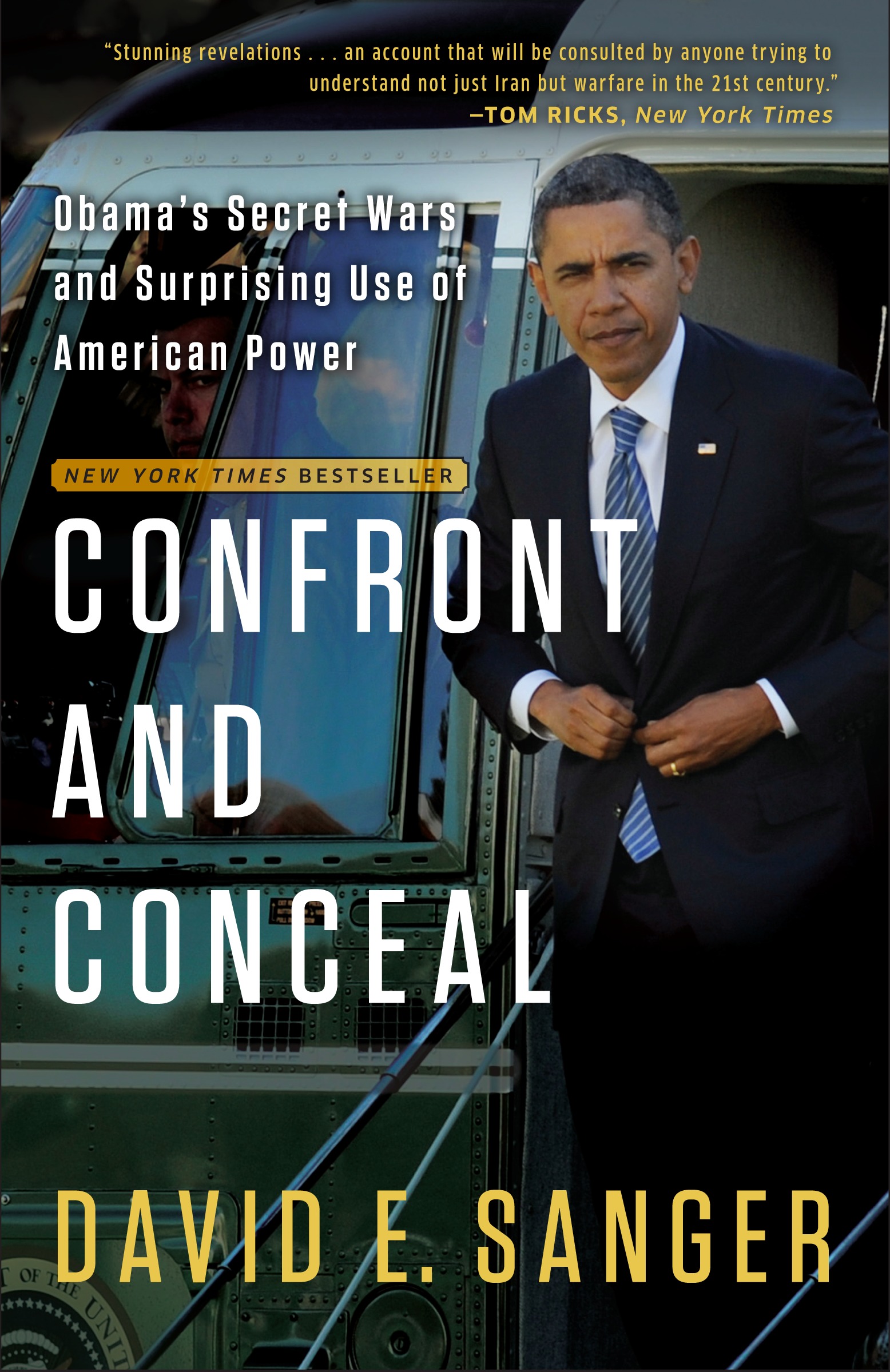
Confront and Conceal FROM INSIDE OBAMA’S SITUATION ROOM . . . THE CRITICAL MOMENTS IN THE COVERT WAR AGAINST IRAN, THE STRUGGLES TO DEAL WITH A RECALCITRANT PAKISTAN AND ITS FAST-GROWING NUCLEAR ARSENAL, THE TENSIONS WITH THE AMERICAN MILITARY OVER AFGHANISTAN AND WITH ALLIES SWEPT UP IN THE CHAOS OF THE ARAB SPRING Three and a half years ago, David Sanger’s book The Inheritance: The World Obama Confronts and the Challenges to American Power described how a new American president came to office with the world on fire. Now, just as the 2012 presidential election battle begins, Sanger follows up with an eye-opening, news-packed account of how Obama has dealt with those challenges, relying on innovative weapons and reconfigured tools of American power to try to manage a series of new threats. Sanger describes how Obama’s early idealism about fighting “a war of necessity” in Afghanistan quickly turned to fatigue and frustration, how the early hopes that the Arab Spring would bring about a democratic awakening slipped away, and how an effort to re-establish American power in the Pacific set the stage for a new era of tensions with the world’s great rising power, China. As the world seeks to understand the contours of the Obama Doctrine, Confront and Conceal is a fascinating, unflinching account of these complex years, in which the president and his administration have found themselves struggling to stay ahead in a world where power is diffuse and America’s ability to exert control grows ever more elusive. POLITICAL SCIENCE,American Government,Executive Branch
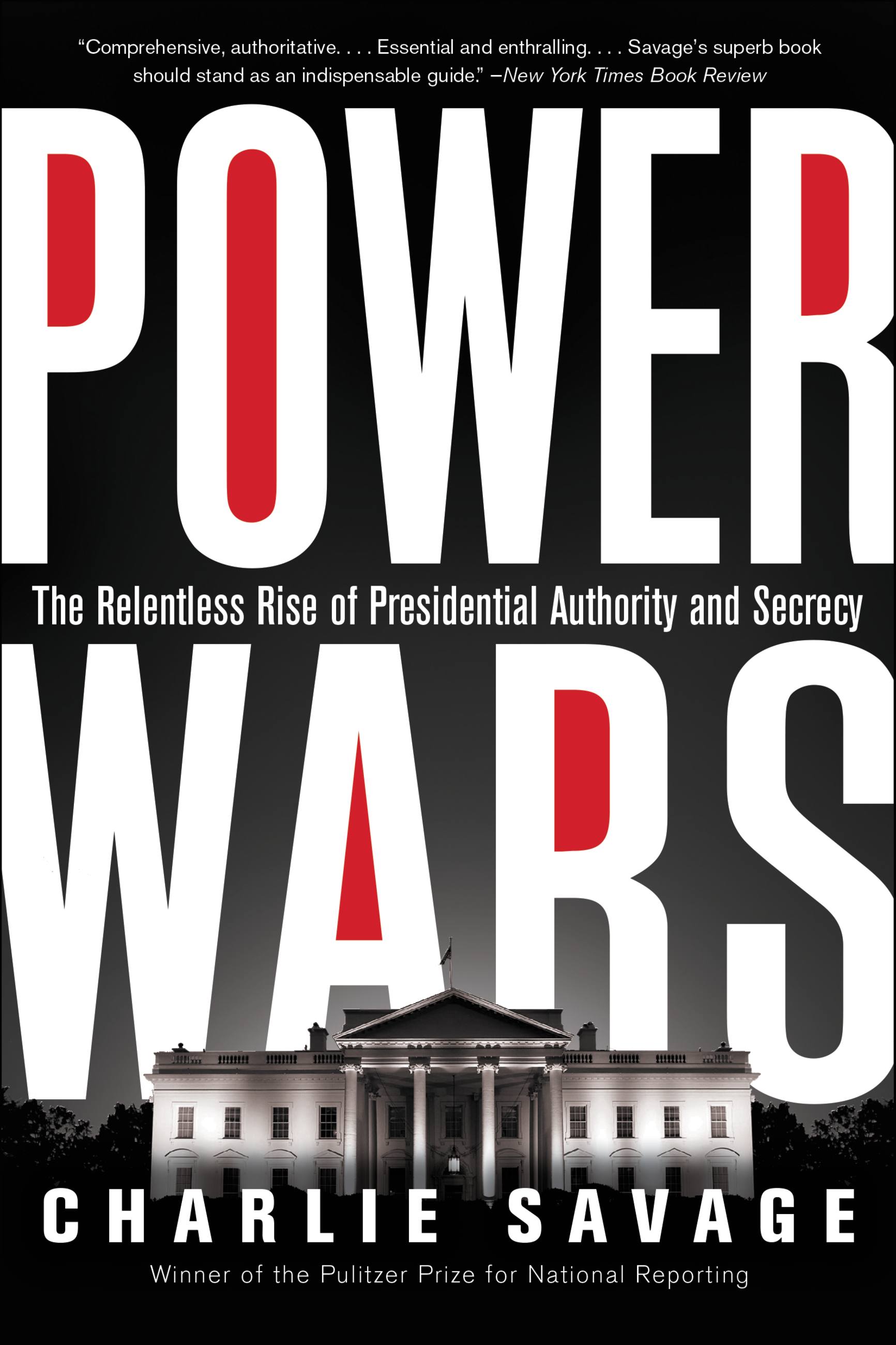
Power Wars Pulitzer Prize-winning journalist Charlie Savage's penetrating investigation of the Obama presidency and the national security state. Barack Obama campaigned on changing George W. Bush's "global war on terror" but ended up entrenching extraordinary executive powers, from warrantless surveillance and indefinite detention to military commissions and targeted killings. Then Obama found himself bequeathing those authorities to Donald Trump. How did the United States get here? In Power Wars, Charlie Savage reveals high-level national security legal and policy deliberations in a way no one has done before. He tells inside stories of how Obama came to order the drone killing of an American citizen, preside over an unprecendented crackdown on leaks, and keep a then-secret program that logged every American's phone calls. Encompassing the first comprehensive history of NSA surveillance over the past forty years as well as new information about the Osama bin Laden raid, Power Wars equips readers to understand the legacy of Bush's and Obama's post-9/11 presidencies in the Trump era. POLITICAL SCIENCE,American Government,Executive Branch

Clinton Cash The definitive takedown by the #1 New York Times bestselling author of Secret Empires. In 2000, Bill and Hillary Clinton owed millions of dollars in legal debt. Since then, they’ve earned over $130 million. Where did the money come from? Most people assume that the Clintons amassed their wealth through lucrative book deals and high-six figure fees for speaking gigs. Now, Peter Schweizer shows who is really behind those enormous payments. In his New York Times bestselling books Extortion and Throw Them All Out, Schweizer detailed patterns of official corruption in Washington that led to congressional resignations and new ethics laws. In Clinton Cash, he follows the Clinton money trail, revealing the connection between their personal fortune, their “close personal friends,†the Clinton Foundation, foreign nations, and some of the highest ranks of government. Schweizer reveals the Clinton’s troubling dealings in Kazakhstan, Colombia, Haiti, and other places at the “wild west†fringe of the global economy. In this blockbuster exposé, Schweizer merely presents the troubling facts he’s uncovered. Meticulously researched and scrupulously sourced, filled with headline-making revelations, Clinton Cash raises serious questions of judgment, of possible indebtedness to an array of foreign interests, and ultimately, of fitness for high public office. POLITICAL SCIENCE,American Government,Executive Branch

Understanding Trump Learn how Trump is making America great again -- and why government and media elites attack his vision -- in this "inspiring and informative" book from one of his key political advisors (Sean Hannity). Donald Trump is unlike any president we've ever had. The only person ever elected to be commander in chief who has not first held public office or served as a general in the military, Trump's principles grow out of five decades of business and celebrity success -- not politics. The president owes his position to the people who believed in him as a candidate, not to the left-wing government and media who have expressed contempt for him since his first day on the campaign trail. Trump has enacted policies and set goals that send our country in a bold new direction -- one that is "unreasonable" to Washington elites but sensible to millions of Americans outside the Beltway. With Understanding Trump, Newt Gingrich provides unique insight into how the president's past experiences have helped to shape his life and style of governing, including a thorough analysis of how President Trump thinks and makes decisions, as well as his philosophy, doctrine, and forward-thinking political agenda. Discover Trump-style solutions for national security, education, health care, economic growth, government reform, and other important topics. In this eye-opening book, Gingrich also investigates and exposes the forces in the Washington establishment, media, and bureaucracy that oppose the president at every turn. Finally, Understanding Trump explains the president's actions so far and lays out a vision for what Americans can do to help make President Trump's agenda a success. With your help, President Trump will be able to overcome corrupt interests in Washington and fulfill his promise to make America great again. POLITICAL SCIENCE,American Government,Executive Branch
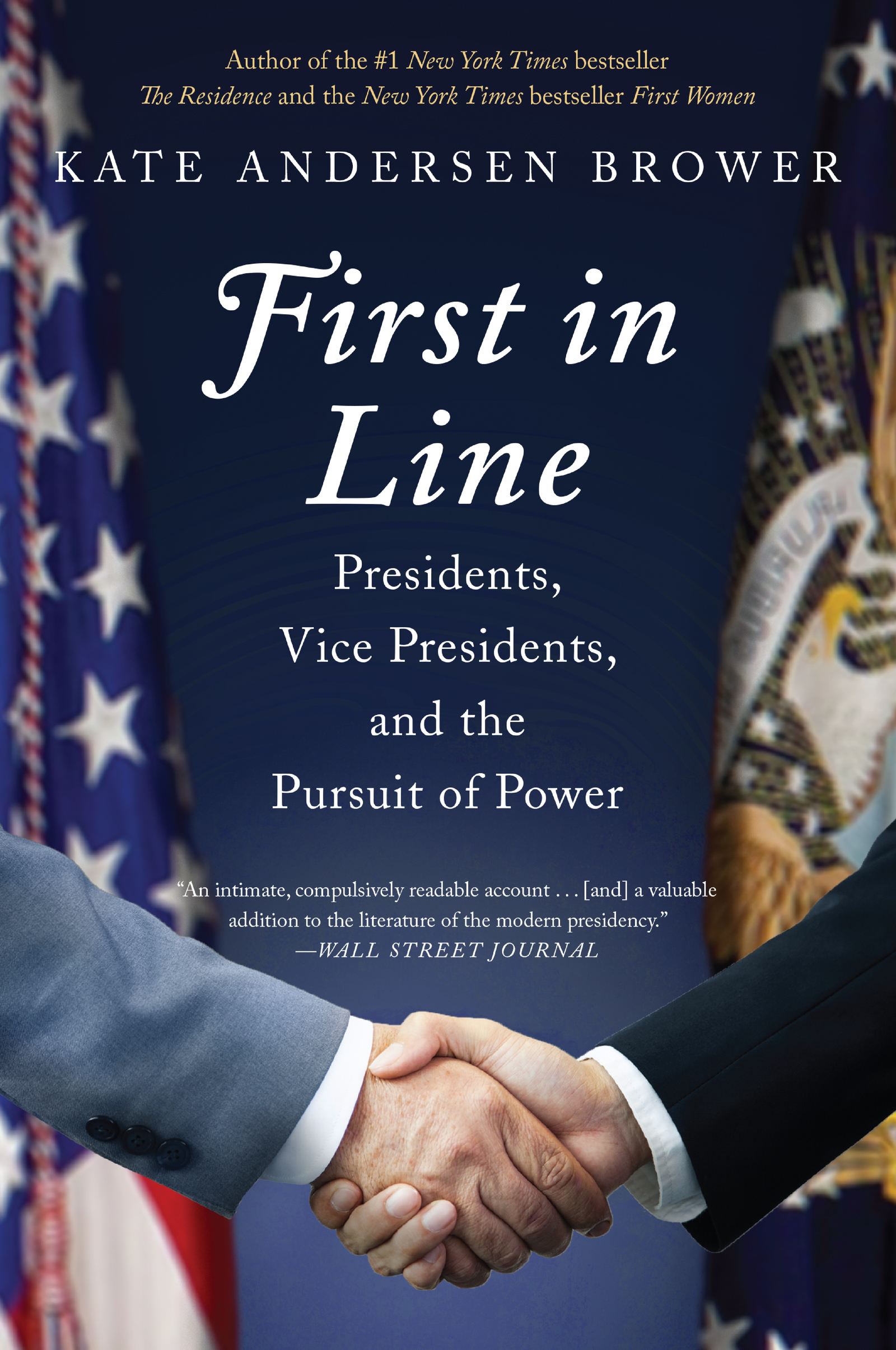
First in Line From the author of the New York Times bestsellers First Women and The Residence, an intimate, news-making look at the men who are next in line to the most powerful office in the world—the vice presidents of the modern era—from Richard Nixon to Joe Biden to Mike Pence. Vice presidents occupy a unique and important position, living partway in the spotlight and part in the wings. Of the forty-eight vice presidents who have served the United States, fourteen have become president; eight of these have risen to the Oval Office because of a president’s death or assassination, and one became president after his boss’s resignation. John Nance Garner, FDR’s first vice president, famously said the vice presidency is "not worth a bucket of warm piss" (later cleaned up to "warm spit"). But things have changed dramatically in recent years. In interviews with more than two hundred people, including former vice presidents, their family members, and insiders and confidants of every president since Jimmy Carter, Kate Andersen Brower pulls back the curtain and reveals the sometimes cold, sometimes close, and always complicated relationship between our modern presidents and their vice presidents. Brower took us inside the lives of the White House staff and gave us an intimate look at the modern First Ladies; now, in her signature style, she introduces us to the second most powerful men in the world, exploring the lives and roles of thirteen modern vice presidents—eight Republicans and five Democrats. And she shares surprising revelations about the relationship between former Vice President Joe Biden and former President Barack Obama and how Vice President Mike Pence and President Donald Trump interact behind closed doors. From rivals to coworkers, there is a very tangible sense of admiration mixed with jealousy and resentment in nearly all these relationships between the number two and his boss, even the best ones, Brower reveals. Vice presidents owe their position to the president, a connection that affects not only how they are perceived but also their possible future as a presidential candidate—which is tied, for better or worse, to the president they serve. George H. W. Bush and Ronald Reagan had a famously prickly relationship during the 1980 primary, yet Bush would not have been elected president in 1988 without Reagan’s high approval rating. Al Gore’s 2000 loss, meanwhile, could be attributed to the Monica Lewinsky sex scandal and Bill Clinton’s impeachment. Current Vice President Mike Pence is walking a high-stakes political tightrope as he tries to reassure anxious Republicans while staying on his boss’s good side. This rich dynamic between the president and the vice president has never been fully explored or understood. Compelling and deeply reported, grounded in history and politics, and full of previously untold and incredibly personal stories, First In Line pierces the veil of secrecy enveloping this historic political office to offer us a candid portrait of what it’s truly like to be a heartbeat away. POLITICAL SCIENCE,American Government,Executive Branch

Secrets of the Secret Service From the author of the #1 New York Times bestseller CRISIS OF CHARACTER comes an explosive new exposé of the Secret Service. The United States Secret Service is tasked with protecting our Presidents, their families, and the complex in which they live and work. Given this important mission, world stability rests upon the shoulders of its agents. In his new book, former Secret Service officer Gary Byrne takes readers behind the scenes to understand the agency's history and today's security failings that he believes put Americans at risk The American public knows the stories of Secret Service heroism, but they don't know about the hidden legacy of problems that have plagued the agency ever since its creation. Gary Byrne says that decades of catastrophic public failures, near misses, and bureaucratic and cultural rot threaten to erode this critical organization from the inside out. Today, as it works to protect President Trump, the Secret Service stands at a crossroads, and the time needed to choose the right course is running out. Agents and officers are leaving the Secret Service in droves, or they're being overworked to the point where they lose focus on the job. Management makes decisions based on politics, not the welfare of their employees. Byrne believes that this means danger for the men and women of the Secret Service, danger for the President they protect, and danger for the nation. In this book, he shares what he has witnessed and learned about the Secret Service with the hope that the problems of this most important agency can be fixed before it's too late. POLITICAL SCIENCE,American Government,Executive Branch

Fire and Fury #1 New York Times Bestseller With extraordinary access to the West Wing, Michael Wolff reveals what happened behind-the-scenes in the first nine months of the most controversial presidency of our time in Fire and Fury: Inside the Trump White House. Since Donald Trump was sworn in as the 45th President of the United States, the country—and the world—has witnessed a stormy, outrageous, and absolutely mesmerizing presidential term that reflects the volatility and fierceness of the man elected Commander-in-Chief. This riveting and explosive account of Trump’s administration provides a wealth of new details about the chaos in the Oval Office, including:-- What President Trump’s staff really thinks of him -- What inspired Trump to claim he was wire-tapped by President Obama -- Why FBI director James Comey was really fired -- Why chief strategist Steve Bannon and Trump’s son-in-law Jared Kushner couldn’t be in the same room -- Who is really directing the Trump administration’s strategy in the wake of Bannon’s firing -- What the secret to communicating with Trump is -- What the Trump administration has in common with the movie The Producers Never before in history has a presidency so divided the American people. Brilliantly reported and astoundingly fresh, Fire and Fury shows us how and why Donald Trump has become the king of discord and disunion. “Essential reading.â€â€”Michael D’Antonio, author of Never Enough: Donald Trump and the Pursuit of Success, CNN.com “Not since Harry Potter has a new book caught fire in this way…[Fire and Fury] is indeed a significant achievement, which deserves much of the attention it has received.â€â€”The Economist POLITICAL SCIENCE,American Government,Executive Branch

Fuego y Furia Con acceso extraordinario a la Casa Blanca de Trump, Michael Wolff cuenta la historia interna de la presidencia más controversial de nuestro tiempo. Los primeros nueve meses del mandato de Donald Trump fueron tormentosos, escandalosos y absolutamente fascinantes. Ahora, gracias a su amplio acceso al Ala Oeste, el exitoso autor Michael Wolff cuenta en este libro explosivo la increíble historia de cómo Trump comenzó su presidencia de manera tan volátil y furiosa como él mismo, y proporciona al lector abundante información inédita sobre el caos que reina en la Casa Blanca. Nunca antes una presidencia había dividido al pueblo estadounidense de tal manera. Brillantemente informado y asombrosamente fresco, Fuego y Furia de Michael Wolff nos muestra cómo y por qué Donald Trump se ha convertido en el rey de la discordia y la desunión. POLITICAL SCIENCE,American Government,Executive Branch
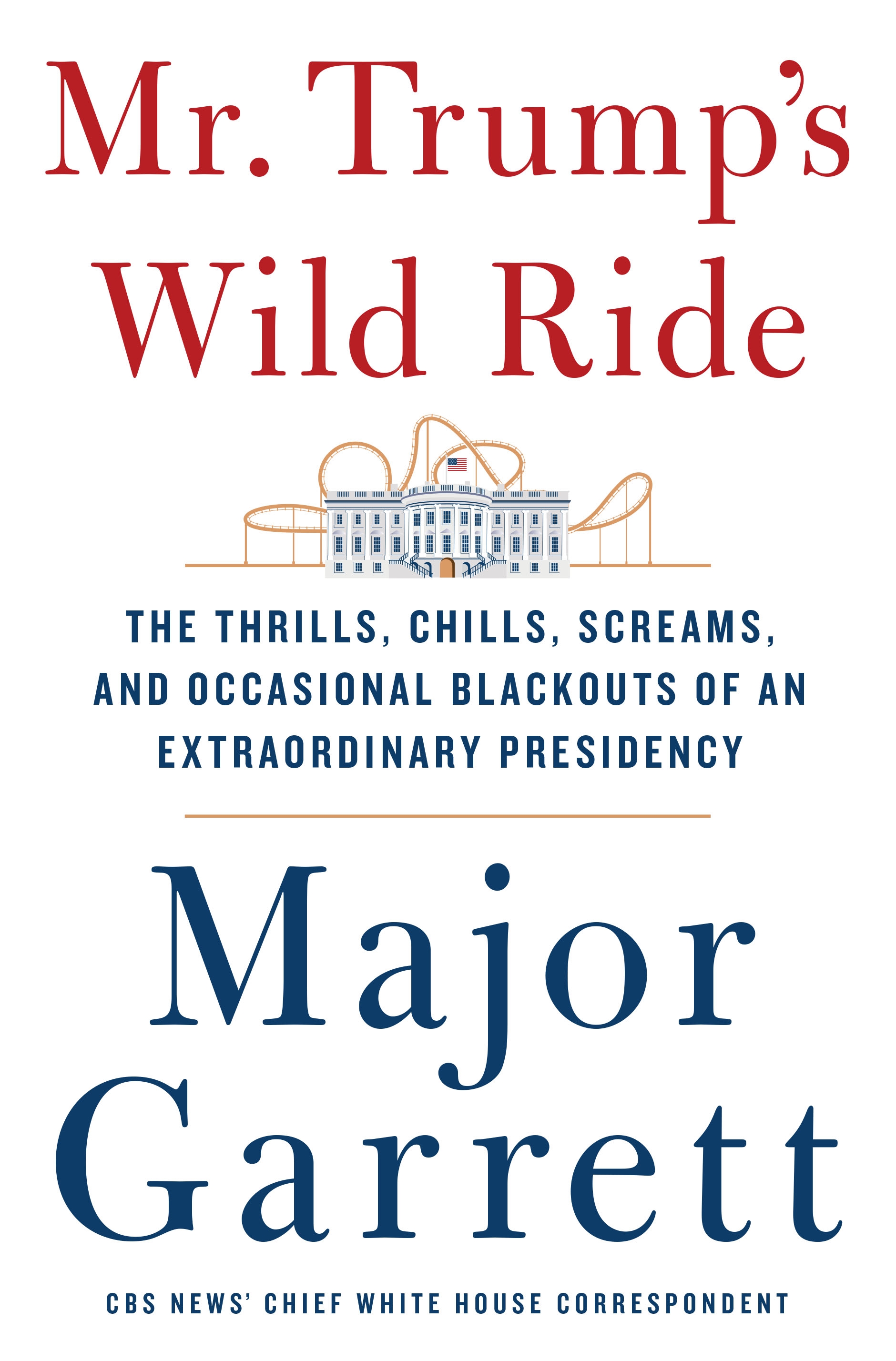
Mr. Trump's Wild Ride A seasoned White House correspondent surveys an unusual presidency and answers the most important question: Does Trump matter? POLITICAL SCIENCE,American Government,Executive Branch
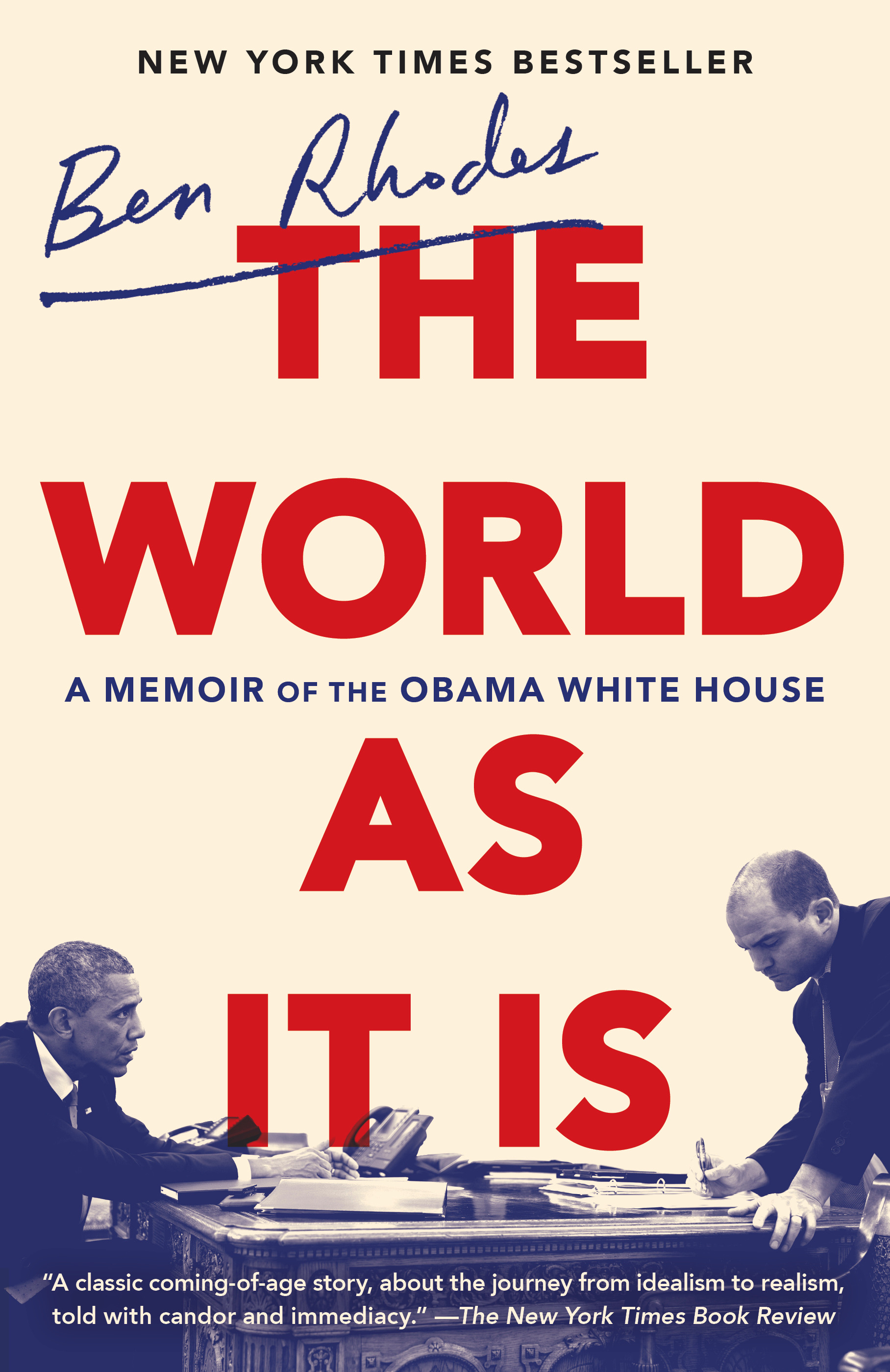
The World as It Is NEW YORK TIMES BESTSELLER • From one of Barack Obama’s most trusted aides comes a revelatory behind-the-scenes account of his presidency—and how idealism can confront harsh reality and still survive. “The closest view of Obama we’re likely to get until he publishes his own memoir.”—George Packer, The New Yorker NAMED ONE OF THE BEST BOOKS OF THE YEAR BY THE GUARDIAN For nearly ten years, Ben Rhodes saw almost everything that happened at the center of the Obama administration—first as a speechwriter, then as deputy national security advisor, and finally as a multipurpose aide and close collaborator. He started every morning in the Oval Office with the President’s Daily Briefing, traveled the world with Obama, and was at the center of some of the most consequential and controversial moments of the presidency. Now he tells the full story of his partnership—and, ultimately, friendship—with a man who also happened to be a historic president of the United States. Rhodes was not your typical presidential confidant, and this is not your typical White House memoir. Rendered in vivid, novelistic detail by someone who was a writer before he was a staffer, this is a rare look inside the most poignant, tense, and consequential moments of the Obama presidency—waiting out the bin Laden raid in the Situation Room, responding to the Arab Spring, reaching a nuclear agreement with Iran, leading secret negotiations with the Cuban government to normalize relations, and confronting the resurgence of nationalism and nativism that culminated in the election of Donald Trump. In The World as It Is, Rhodes shows what it was like to be there—from the early days of the Obama campaign to the final hours of the presidency. It is a story populated by such characters as Susan Rice, Samantha Power, Hillary Clinton, Bob Gates, and—above all—Barack Obama, who comes to life on the page in moments of great urgency and disarming intimacy. This is the most vivid portrayal yet of Obama’s worldview and presidency, a chronicle of a political education by a writer of enormous talent, and an essential record of the forces that shaped the last decade. Praise for The World as It Is “A book that reflects the president [Rhodes] served—intelligent, amiable, compelling and principled . . . a classic coming-of-age story, about the journey from idealism to realism, told with candor and immediacy . . . His achievement is rare for a political memoir: He has written a humane and honorable book.”—Joe Klein, The New York Times Book Review POLITICAL SCIENCE,American Government,Executive Branch

Trump, the Blue-Collar President In an administration not known for its subtlety, no comet soared higher, burned brighter, or flamed out more spectacularly than Anthony Scaramucci. For eleven days (not ten, as widely reported, he'll tell anyone who'll listen) he ran the most important communications department in the world, the White House's. By the end of his short tenure -- several of the most tumultuous and formative days of the Trump administration -- he'd gone from a fairly well known on-air surrogate for the president to a household name, "the Mooch." The rise and fall of the Mooch, which riveted the nation, unfolded like a Shakespearean play directed by Martin Scorsese. In his own inimitable voice, Anthony reveals the juicy details behind his stormy term as White House communications director. He holds nothing back and spares no one's feelings-including those of the country's most powerful people. If political movements are best understood through a single human life, then there is no better life to tell the story of Donald Trump's rise in America than the Mooch's. From Long Island Newsday paperboy, with the largest route in Port Washington, to Master of the Universe, as Tom Wolfe characterized his kind in Bonfire of the Vanities, Anthony's life was the embodiment of the American Dream. By his own admission, however, he became so involved in his high-octane career and life that he forgot his working-class roots. He wasn't the only one to ignore the working class. There were neighborhoods like the one he grew up in throughout the country filled with deflated, unemployed, or underpaid people, ignored by elites and politicians-until Donald Trump came along. It was only when Anthony joined the Donald Trump for President campaign as a surrogate and economic advisor that his eyes were opened to the plight of our country's middle class. It took a billionaire real estate developer who lived in a tower on Fifth Ave to show him what had happened to the neighborhood in which he'd grown up and communities like it throughout America. It was then that Anthony realized that Donald Trump and his economic policies were the best bet for our country's future. A romp of a read, by turns hilarious, touching, and inspiring, Trump, the Blue-Collar President is sure to be among the best books written about the Trump presidency. POLITICAL SCIENCE,American Government,Executive Branch

The Man Who Sold America THE NEW YORK TIMES BESTSELLER MSNBC'S Joy-Ann Reid calculates the true price of the Trump presidency and charts the road to Congress's impeachment investigation "The host of AM Joy on MSNBC argues that President Trump’s administration is characterized by grift and venality that demeans the office and diminishes America.†—New York Times Book Review Is Donald Trump running the “longest con†in U.S. history? How did we get here? What will be left of America when he leaves office? Candidate Trump sold Americans a vision that was seemingly at odds with their country’s founding principles. Now in office, he’s put up a “for sale†sign—on the prestige of the presidency, on America’s global stature, and on our national identity. At what cost have these deals come? Joy-Ann Reid's essential new book, The Man Who Sold America, delivers an urgent accounting of our national crisis from one of our foremost political commentators. Three years ago, Donald Trump pitched millions of voters on the idea that their country was broken, and that the rest of the world was playing us “for suckers.†All we needed to fix this was Donald Trump, who rebranded prejudice as patriotism, presented diversity as our weakness, and promised that money really could make the world go ’round. Trump made the sale to enough Americans in three key swing states to win the Electoral College. As president, Trump’s raft of self-dealing, scandal, and corruption has overwhelmed the national conversation. And with prosecutors bearing down on Trump and his family business, the web of criminality is circling closer to the Oval Office. All this while Trump seemingly makes his administration a pawn for the ultimate villain: an autocratic former KGB officer in Russia who found in the untutored and eager forty-fifth president the perfect “apprentice.†What is the hidden impact of Trump, beyond the headlines? Through interviews with American and international thought leaders and in-depth analysis, Reid situates the Trump era within the context of modern history, examining the profound social changes that led us to this point. Providing new context and depth to our understanding, The Man Who Sold America reveals the causes and consequences of the Trump presidency and contends with the future that awaits us. POLITICAL SCIENCE,American Government,Executive Branch

Unhinged In the #1 New York Times bestseller, the former Assistant to the President and Director of Communications for the Office of Public Liaison in the Trump White House provides an eye-opening and “explosive†(The Boston Globe) look into the corruption and controversy of the current administration. Few were a member of Donald Trump’s inner orbit longer than Omarosa Manigault Newman. Their relationship spanned fifteen years—through four television shows, a presidential campaign, and a year by his side in the most chaotic, outrageous White House in history. But that relationship came to a decisive and definitive end, and Omarosa finally shares her side of the story in this “deftly executed†(The Guardian), jaw-dropping account. A stunning tell-all and takedown from a strong, intelligent woman who took every name and number, Unhinged is a must-read for any concerned citizen. POLITICAL SCIENCE,American Government,Executive Branch

Nixon The rise, fall, and rebirth of Richard Nixon is perhaps the most fascinating story in American politicsand perhaps the most misunderstood. Nixon: A Life is the first entirely objective biography of Richard Nixon. Former British Defense Minister Jonathan Aitken conducted over sixty hours of interviews with the impeached former president and was granted unprecedented access to thousands of pages of Nixon’s previously sealed private documents. Nixon reveals to Aitken why he didn’t burn the Watergate tapes, how he felt when he resigned the presidency, his driving spiritual beliefs, and more. Nixon: A Life breaks important new ground as a major work of political biography, inspiring historians to recognize the outstanding diplomatic achievements of a man whose journey from tainted politician to respected foreign policy expert and elder statesman was nothing short of remarkable. POLITICAL SCIENCE,American Government,Executive Branch

Fear OVER 2 MILLION COPIES SOLD RUNAWAY #1 NEW YORK TIMES BESTSELLER SENSATIONAL #1 INTERNATIONAL BESTSELLER “Explosive.â€â€”The Washington Post “Devastating.â€â€”The New Yorker “Unprecedented.â€â€”CNN “Great reporting...astute.†—Hugh Hewitt THE INSIDE STORY ON PRESIDENT TRUMP, AS ONLY BOB WOODWARD CAN TELL IT With authoritative reporting honed through nine presidencies, author Bob Woodward reveals in unprecedented detail the harrowing life inside President Donald Trump’s White House and precisely how he makes decisions on major foreign and domestic policies. Fear is the most intimate portrait of a sitting president ever published during the president’s first years in office. The focus is on the explosive debates and the decision-making in the Oval Office, the Situation Room, Air Force One and the White House residence. Woodward draws from hundreds of hours of interviews with firsthand sources, meeting notes, personal diaries, files and documents. Often with day-by-day details, dialogue and documentation, Fear tracks key foreign issues from North Korea, Afghanistan, Iran, the Middle East, NATO, China and Russia. It reports in-depth on Trump’s key domestic issues particularly trade and tariff disputes, immigration, tax legislation, the Paris Climate Accord and the racial violence in Charlottesville in 2017. Fear presents vivid details of the negotiations between Trump’s attorneys and Robert Mueller, the special counsel in the Russia investigation, laying out for the first time the meeting-by-meeting discussions and strategies. It discloses how senior Trump White House officials joined together to steal draft orders from the president’s Oval Office desk so he would not issue directives that would jeopardize top secret intelligence operations. “It was no less than an administrative coup d’état,†Woodward writes, “a nervous breakdown of the executive power of the most powerful county in the world.†POLITICAL SCIENCE,American Government,Executive Branch

Kushner, Inc. INSTANT NEW YORK TIMES BESTSELLER The first explosive book about Javanka and their infamous rise to power Jared Kushner and Ivanka Trump are the self-styled Prince and Princess of America. Their swift, gilded rise to extraordinary power in Donald Trump’s White House is unprecedented and dangerous. In Kushner, Inc., investigative journalist Vicky Ward digs beneath the myth the couple has created, depicting themselves as the voices of reason in an otherwise crazy presidency, and reveals that Jared and Ivanka are not just the President’s chief enablers: they, like him, appear disdainful of rules, of laws, and of ethics. They are entitled inheritors of the worst kind; their combination of ignorance, arrogance, and an insatiable lust for power has caused havoc all over the world, and may threaten the democracy of the United States. Ward follows their trajectory from New Jersey and New York City to the White House, where the couple’s many forays into policy-making and national security have mocked long-standing U.S. policy and protocol. They have pursued an agenda that could increase their wealth while their actions have mostly gone unchecked. In Kushner, Inc., Ward holds Jared Kushner and Ivanka Trump accountable: she unveils the couple’s self-serving transactional motivations and how those have propelled them into the highest levels of the US government where no one, the President included, has been able to stop them. POLITICAL SCIENCE,American Government,Executive Branch

Team of Five From the #1 New York Times bestselling author of The Residence and First Women—also a New York Times bestseller—comes a poignant, news-making look at the lives of the five former presidents in the wake of their White House years, including the surprising friendships they have formed through shared perspective and empathy. After serving the highest office of American government, five men—Jimmy Carter, the late George H. W. Bush, Bill Clinton, George W. Bush, and Barack Obama—became members of the world’s most exclusive fraternity. In Team of Five, Kate Andersen Brower goes beyond the White House to uncover what, exactly, comes after the presidency, offering a glimpse into the complex relationships of these five former presidents, and how each of these men views his place in a nation that has been upended by the Oval Office’s current, norm-breaking occupant, President Donald Trump. With an empathetic yet critical eye and firsthand testimony from the Carters, Donald Trump, and the top aides, friends, and family members of the five former presidents, Team of Five takes us inside the exclusive world of these powerful men and their families, including the unlikely friendship between George W. Bush and Michelle Obama, the last private visits Bill Clinton and Barack Obama shared with George H.W. Bush, and the Obamas’ flight to Palm Springs after Donald Trump’s inauguration. Perhaps most timely, this insightful, illuminating book overflows with anecdotes about how the ex-presidents are working to combat President Trump’s attempts to undo the achievements and hard work accomplished during their own terms. Perhaps most poignantly, Team of Five sheds light on the inherent loneliness and inevitable feelings of powerlessness and frustration that come with no longer being the most important person in the world, but a leader with only symbolic power. There are ways, though, that these men, and their wives, have become powerful political and cultural forces in American life, even as so-called “formers.†Team of Five includes 16 pages of color photographs. POLITICAL SCIENCE,American Government,Executive Branch
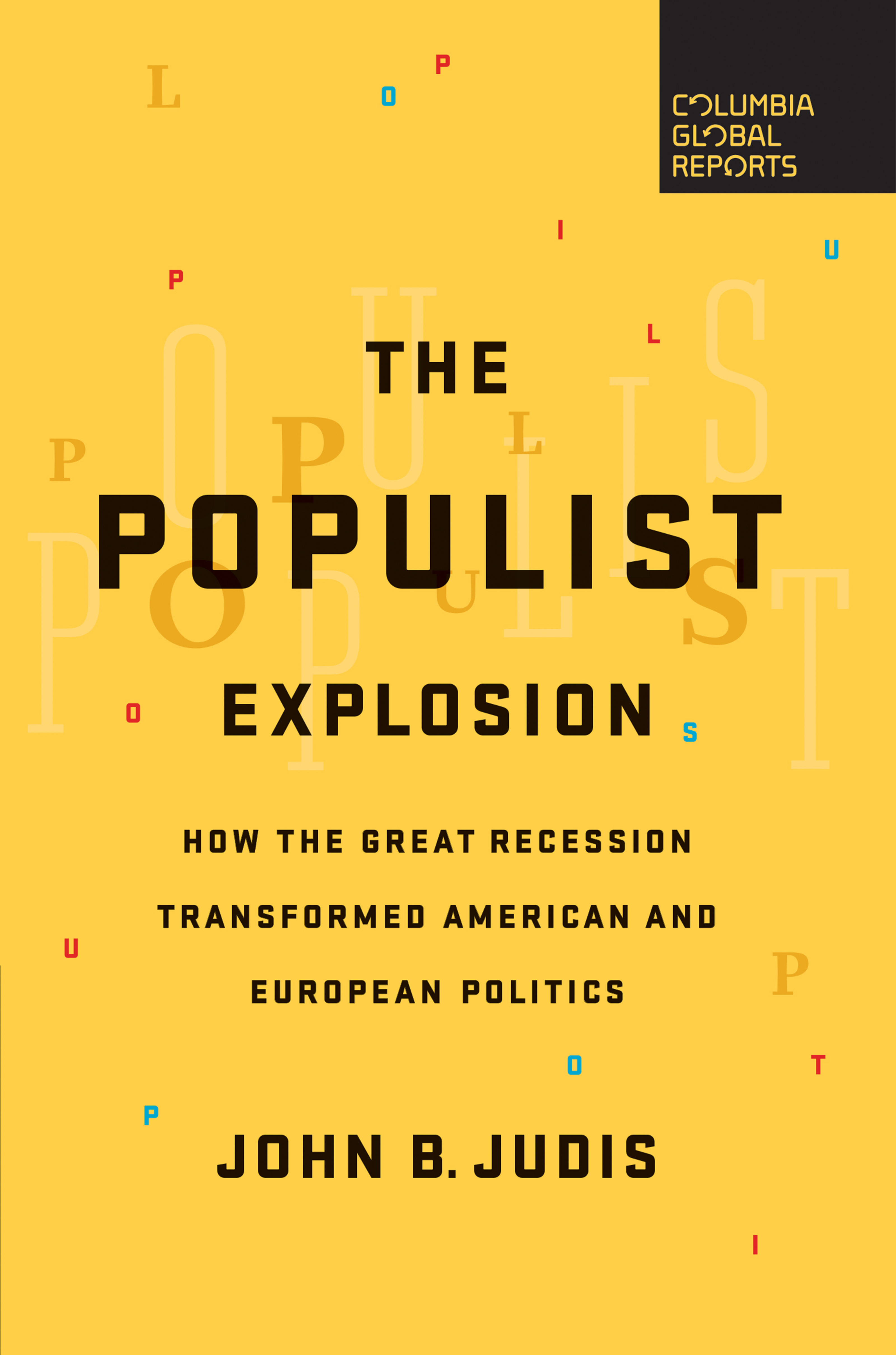
The Populist Explosion One of The New York Times' 6 Books to Help Understand Trump's Win A Fareed Zakaria GPS Book of the Week: "An intelligent guide to a phenomenon by no means over." - Fareed Zakaria, CNN "Well-written and well-researched, powerfully argued and perfectly timed." — The Economist Named one of the Best Books of 2016 by Bloomberg "Far and away the most incisive examination of the central development in contemporary politics: the rise of populism on both the right and the left. Superb." -- Thomas Edsall, New York Times columnist What's happening in global politics? As if overnight, many Democrats revolted and passionately backed a socialist named Bernie Sanders; the United Kingdom voted to leave the European Union ; the vituperative billionaire Donald Trump became the presidential nominee of the Republican party; and a slew of rebellious parties continued to win elections in Switzerland, Norway, Italy, Austria, and Greece. John B. Judis, one of America's most respected political analysts, tells us why we need to learn about the populist movement that began in the United States in the 1890s, the politics of which have recurred on both sides of the Atlantic ever since. Populism, on both the right and the left, champions the people against an establishment, based on issues--globalization, free trade, immigration--on which there has been a strong elite consensus, but also a strong mass discontent that is now breaking out into the open. The Populist Explosion is essential reading for our times as we grapple to understand the political forces at work here and in Europe. POLITICAL SCIENCE,American Government,Executive Branch

Mar-a-Lago Where Trump Learned to Rule To know Donald J. Trump it is best to start in his natural habitat: Palm Beach, Florida. It is here he learned the techniques that took him all the way to the White House. Painstakingly, over decades, he has created a world in this exclusive tropical enclave and favorite haunt of billionaires where he is not just president but a king. The vehicle for his triumph is Mar-A-Lago, one of the greatest mansions ever built in the United States. The inside story of how he became King of Palm Beach—and how Palm Beach continues to be his spiritual home even as president—is rollicking, troubling, and told with unrivaled access and understanding by Laurence Leamer. In Mar-A-Lago, the reader will learn: * How Donald Trump bought a property now valued by some at as much as $500,000,000 for less than three thousand dollars of his own money. * Why Trump was blackballed by the WASP grandees of the island and how he got his revenge. * How Trump joined forces with the National Enquirer, which was headquartered nearby, and engineered his own divorce. * How by turning Mar-A-Lago into a private club, Trump was the unlikely man to integrate Palm Beach’s restricted country club scene, and what his real motives were. * What transpires behind the gates of today’s Mar-A-Lago during “the season,†when President Trump and assorted D.C. power players fly down each weekend. In addition to copious interviews and reporting from inside Mar-A-Lago, Laurence Leamer brings an acute and unparalleled understanding of the society of Palm Beach, where he has lived for twenty-five years. He has written an essential book for understanding Donald Trump’s inner character. POLITICAL SCIENCE,American Government,Executive Branch

50 Things They Don't Want You to Know Breitbart.com editor Jerome Hudson delivers the red pills his readers know him for, showing you the facts, statistics, and analysis that the mainstream media have worked so hard to hide Description: If you heard that one president deported more people than any other president, started the program of family separation, and did nothing to stop Russia’s election meddling, how many of them would guess it was Obama? In 50 Things They Don’t Want You to Know Jerome Hudson dives deeply into the things Americans are not supposed to realize. Many of our most hotly debate topics are shaped by Davos power brokers, woke college professors, TV talking heads, social media activists and feckless Washington swamp monsters who want you to only follow their narrative. Your teachers, your politicians, and your local paper are not likely to ever tell you: Racial minorities fare far better in the absence of race-based affirmative action policies. Latinos make up a little more than 50% of the Border Patrol, according to 2016 data. The U.S. settled more refugees in 2017 than any other nation. Between 2011 and 2016, the IRS documented 1.3 million identity thefts by Illegal aliens. Half of federal arrests are immigration-related. Welfare recipients in 34 states earn more than a person making minimum wage. Taxpayers doled out $2.6 billion in food stamps to dead people in less than two years. 1,700 private jets flew to Davos to discuss the impact of global warming. Google could swing an election by secretly adjusting its search algorithm, and we would have no way of knowing. Once you’re done reading 50 Things They Don’t Want You to Know, you’ll never trust the powers that be to give you the whole truth again. POLITICAL SCIENCE,American Government,Executive Branch
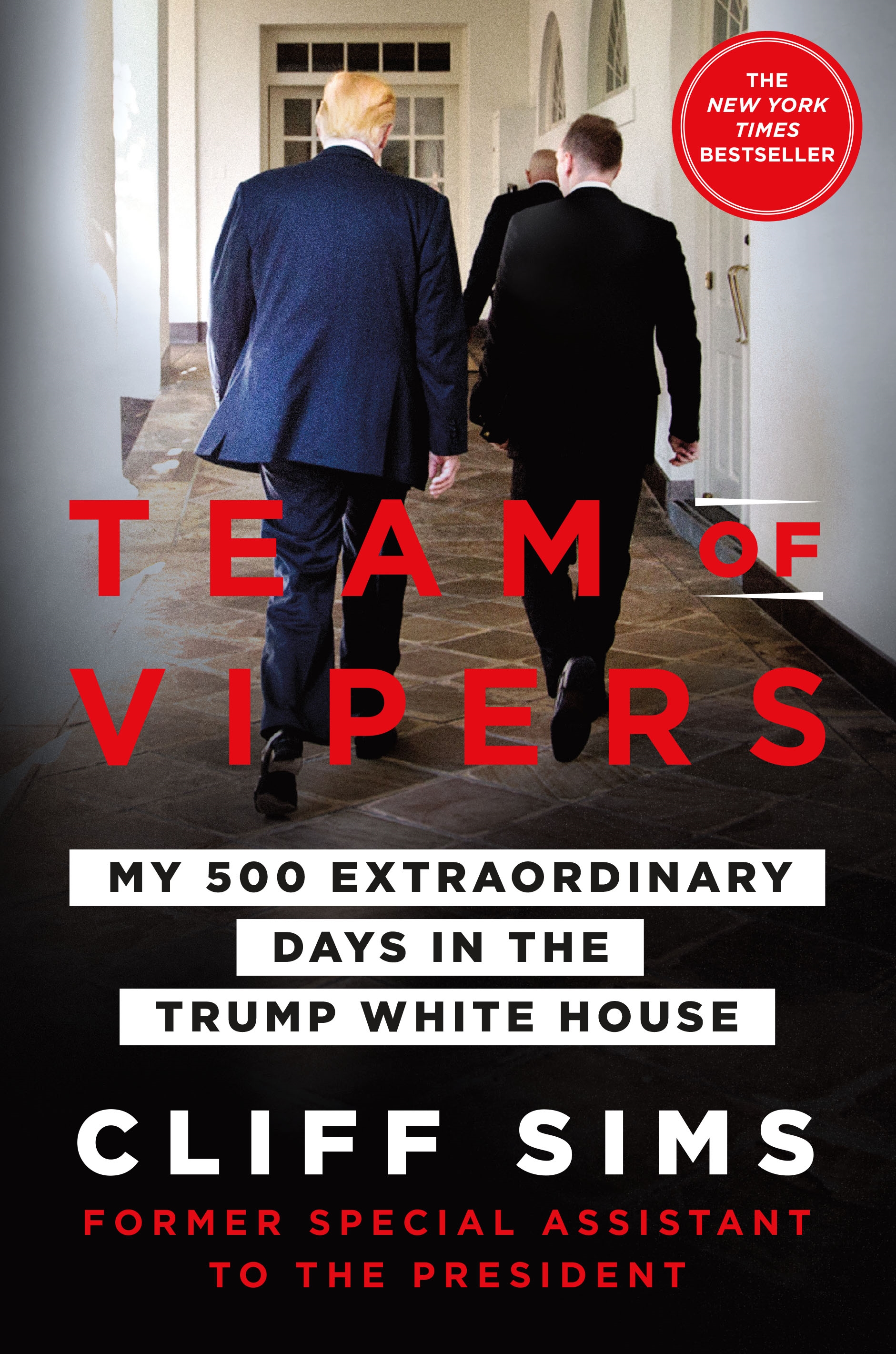
Team of Vipers THE INSTANT NEW YORK TIMES BESTSELLER "Sims’s vivid portrait of Trump shrewdly balances admiration with misgivings, and his intricate, engrossing accounts of White House vendettas and power plays have a good mix of immersion and perspective. The result is one of the best of the recent flood of Trump tell-alls." —Publishers Weekly The first honest insider’s account of the Trump administration. If you hate Trump you need the truth; if you love Trump you need the truth. After standing at Donald Trump’s side on Election Night, Cliff Sims joined him in the West Wing as Special Assistant to the President and Director of White House Message Strategy. He soon found himself pulled into the President’s inner circle as a confidante, an errand boy, an advisor, a punching bag, and a friend. Sometimes all in the same conversation. As a result, Sims gained unprecedented access to the President, sitting in on private meetings with key Congressional officials, world leaders, and top White House advisors. He saw how Trump handled the challenges of the office, and he learned from Trump himself how he saw the world. For five hundred days, Sims also witnessed first-hand the infighting and leaking, the anger, joy, and recriminations. He had a role in some of the President’s biggest successes, and he shared the blame for some of his administration’s worst disasters. He gained key, often surprising insights into the players of the Trump West Wing, from Jared Kushner and John Kelly to Steve Bannon and Kellyanne Conway. He even helped Trump craft his enemies list, knowing who was loyal and who was not. And he took notes. Hundreds of pages of notes. In real-time. Sims stood with the President in the eye of the storm raging around him, and now he tells the story that no one else has written—because no one else could. The story of what it was really like in the West Wing as a member of the President’s team. The story of power and palace intrigue, backstabbing and bold victories, as well as painful moral compromises, occasionally with yourself. Team of Vipers tells the full story, as only a true insider could. POLITICAL SCIENCE,American Government,Executive Branch

Traitor "Rothkopf does a brilliant job defining precisely how Trump has been aiding and abetting the enemy... compelling." --Financial Times Political historian and commentator David Rothkopf shows how Trump will be judged by history (Spoiler alert: not well) in Traitor. Donald Trump is unfit in almost every respect for the high office he holds. But what distinguishes him from every other bad leader the U.S. has had is that he has repeatedly, egregiously, betrayed his country. Regardless of how Senate Republicans have let him off the hook, the facts available to the public show that Trump has met every necessary standard to define his behavior as traitorous. He has clearly broken faith with the people of the country he was chosen to lead, starting long before he took office, then throughout his time in the White House. And we may not yet have seen the last of his crimes. But the story we know so far is so outrageous and disturbing that it raises a question that has never before been presented in American history: is the president of the United States the greatest threat this country faces in the world? We also need to understand how the country has historically viewed such crimes and how it has treated them in the past to place what has happened in perspective. After his examination of traitors including Benedict Arnold, Aaron Burr, and leaders of the Confederacy, David Rothkopf concludes that Donald Trump and his many abettors have committed the highest-level, greatest, most damaging betrayal in the history of the country. POLITICAL SCIENCE,American Government,Executive Branch

Power Grab A New York Times Bestseller. How much damage will the Democrats do to our republic in the name of saving it? In the years he served on and eventually chaired the United States House Committee on Oversight and Government Reform, Jason Chaffetz gained crucial insight into the inner workings of D.C. Things were bad then, but during the Trump administration, liberals have reached a new level of hysteria and misconduct. Democrat anger has grown so irrational that it has burst through the constitutional guardrails which protect our institutions and our republic. While they constantly label the right “fascist,†the left imposes policies which suppress speech, limit freedom, and empower federal bullies. In Power Grab, Chaffetz pulls back the curtain on the world of hypocrisy, political intrigue, and procedural malfeasance that is Washington D.C. With stories you won't read anywhere else, he shows how the left weaves false narratives, drums up investigations in search of a crime, and refuses to direct congressional oversight towards its appropriate target: the government. Democrats weaponize nonprofit advocacy groups and monetize partisan anger to line the pockets of their political allies. They use “voter enrollment†as a smokescreen to hide their plans to destabilize free elections and seek to politicize federal agencies like the Federal Election Commission, the IRS, and the Department of Justice. It shouldn’t be this way. Democrats have abandoned the wisdom set forth in the Constitution for short-term political wins. Power Grab shows the lengths to which Democrats will go to maintain their grip on power, and how the only thing that will stop them is a return to our founding principles. POLITICAL SCIENCE,American Government,Executive Branch

Witch Hunt The author of the #1 New York Times bestseller The Russia Hoax picks up where that book ended with this hard-hitting, well-reasoned examination of the latest findings about “collusion†between the Trump Administration and the Russians, offering further proof that Special Counsel Robert Mueller’s investigation is nothing more than a politically motivated witch hunt. How did a small group of powerful intelligence officials convince tens of millions of Americans that the president is a traitor, without a shred of evidence? Now that every detail and argument set forth in The Russia Hoax has been borne out by the Mueller report, Jarrett returns with Witch Hunt, providing a hard-hitting, well-reasoned evisceration of what may be the dirtiest trick in political history. No marks have ever been as gullible as distraught Democrats in 2016. Washington insiders broke rule after rule investigating the president, chasing a conspiracy that turned out not to exist. Somehow this was spun into Donald Trump having something to hide. People associated with the president were pushed into plea deals that had nothing to do with Russian “collusion†or discouraged from serving by the threat of huge legal bills. Somehow this was spun into Trump’s lawyers being bullies. The president complained that the investigation was a waste of time, but he allowed it to continue unimpeded to the end. Somehow this was spun into obstruction of justice. In Witch Hun t, Gregg Jarrett uncovers the bureaucratic malfeasance and malicious politicization of our country’s justice system. The law was weaponized for partisan purposes. Even though it was Hillary Clinton’s campaign that collected and disseminated a trove of lies about Trump from a former British spy and Russian operatives, Democrats and the media spun this into a claim that Trump was working for the Russians. Senior officials at the FBI, blinded by their political bias and hatred of Trump, went after the wrong person. At the DOJ, the deputy attorney general discussed secretly recording the president and recruiting members of the cabinet to depose Trump. Those behind the Witch Hunt have either been fired or resigned. Many of them are now under investigation for abuse of power. But what about the pundits who concocted wild narratives in real time on television, or the newspapers which covered the fact that rumors were being investigated without investigating the facts themselves? Factual, highly persuasive, and damning, this must-read expose makes clear that not only was there no “collusion,†but there was not even a basis for Mueller’s investigation of the charge that has attacked Trump and his administration for more than two years. It’s always been a Witch Hunt. POLITICAL SCIENCE,American Government,Executive Branch

Siege Michael Wolff, author of the bombshell bestseller Fire and Fury, once again takes us inside the Trump presidency to reveal a White House under siege. Just one year into Donald Trump’s term as president, Michael Wolff told the electrifying story of a White House consumed by controversy, chaos, and intense rivalries. Fire and Fury, an instant sensation, defined the first phase of the Trump administration; now, in Siege, Wolff has written an equally essential and explosive book about a presidency that is under fire from almost every side. At the outset of Trump’s second year as president, his situation is profoundly different. No longer tempered by experienced advisers, he is more impulsive and volatile than ever. But the wheels of justice are inexorably turning: Robert Mueller’s “witch hunt†haunts Trump every day, and other federal prosecutors are taking a deep dive into his business affairs. Many in the political establishment—even some members of his own administration—have turned on him and are dedicated to bringing him down. The Democrats see victory at the polls, and perhaps impeachment, in front of them. Trump, meanwhile, is certain he is invincible, making him all the more exposed and vulnerable. Week by week, as Trump becomes increasingly erratic, the question that lies at the heart of his tenure becomes ever more urgent: Will this most abnormal of presidencies at last reach the breaking point and implode? Both a riveting narrative and a brilliant front-lines report, Siege provides an alarming and indelible portrait of a president like no other. Surrounded by enemies and blind to his peril, Trump is a raging, self-destructive inferno—and the most divisive leader in American history. POLITICAL SCIENCE,American Government,Executive Branch
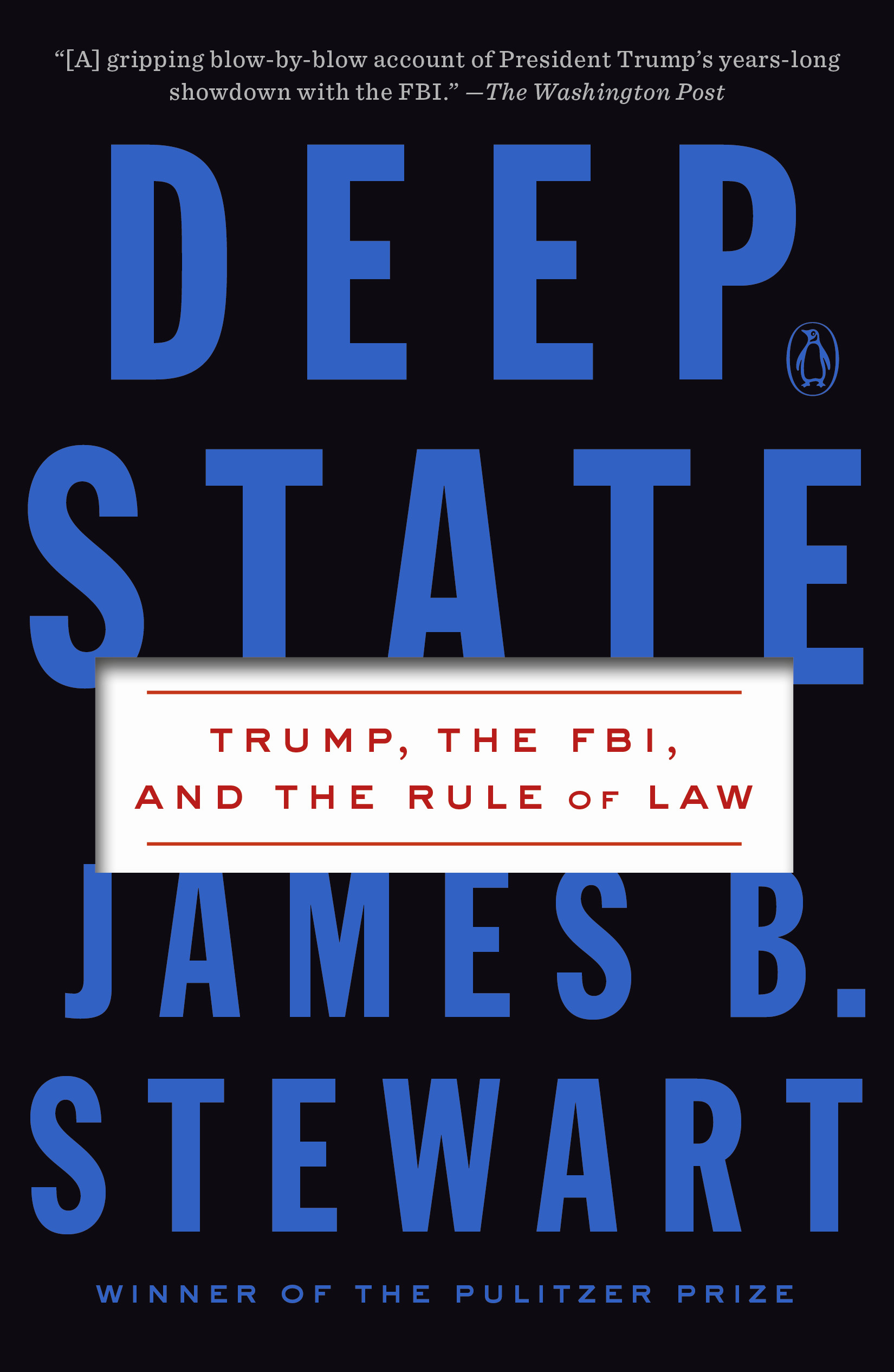
Deep State Instant New York Times Bestseller "Important and stunning. This is must-read material if you want to understand what the Trump administration is still up to right now." --Lawrence O'Donnell There are questions that the Mueller report couldn't—or wouldn't—answer. What actually happened to instigate the Russia investigation? Did President Trump’s meddling incriminate him? There’s no mystery to what Trump thinks. He claims that the Deep State, a cabal of career bureaucrats—among them, Andrew McCabe, Lisa Page, and Peter Strzok, previously little known figures within the FBI whom he has obsessively and publically reviled—is concerned only with protecting its own power and undermining the democratic process. Conversely, James Comey has defended the FBI as incorruptible apolitical public servants who work tirelessly to uphold the rule of law. For the first time, bestselling author James B. Stewart sifts these conflicting accounts to present a clear-eyed view of what exactly happened inside the FBI in the lead-up to the 2016 election, drawing on scores of interviews with key FBI, Department of Justice, and White House officialsand voluminous transcripts, notes, and internal reports. In full detail, this is the dramatic saga of the FBI’s simultaneous investigations of both Hillary Clinton and Donald Trump—the first time in American history the FBI has been thrust into the middle of both parties' campaigns for the presidency. Stewart shows what exactly was set in motion when Trump fired Comey, triggering the appointment of Robert Mueller as an independent special counsel and causing the FBI to open a formal investigation into the president himself. And how this unprecedented event joined in ongoing combat two vital institutions of American democracy: the presidency and the Federal Bureau of Investigation. At stake in this epic battle is the rule of law itself, the foundation of the U.S. Constitution. There is no room for compromise, but plenty for collateral damage. The reputations of both sides have already been harmed, perhaps irrevocably, and at great cost to American democracy. Deep State goes beyond the limits of the legally constrained Mueller report, showing how the president’s obsession with the idea of a conspiracy against him is still upending lives and sending shockwaves through both the FBI and the Department of Justice. In this world-historical struggle—Trump versus intelligence agencies—Stewart shows us in rare style what’s real and what matters now. And for the looming 2020 election. POLITICAL SCIENCE,American Government,Executive Branch

Trumpocalypse "I don't take responsibility at all." Those words of Donald Trump at a March 13, 2020, press conference are likely to be history's epitaph on his presidency. A huge swath of Americans has put their faith in Trump, and Trump only, because they see the rest of the country building a future that doesn’t have a place for them. If they would risk their lives for Trump in a pandemic, they will certainly risk the stability of American democracy. They brought the Trumpocalypse upon the country, and a post-Trumpocalypse country will have to find a way either to reconcile them to democracy - or to protect democracy from them. In Trumpocalypse, David Frum looks at what happens when a third of the electorate refuses to abandon Donald Trump, no matter what he does. Those voters aren’t looking for policy wins. They’re seeking cultural revenge. It is not enough to defeat Donald Trump on election day 2020. Even if Trump peacefully departs office, the trauma he inflicted will distort American and world politics for years to come. Americans must start from where they are, build from what they have, to repair the damage Trump inflicted on the country, to amend the wrongs that, under Trump, they inflicted upon each other. Americans can do better. David Frum shows how—and inspires all readers of all points of view to believe again in the possibilities of American life. Trumpocalypse is both a warning of danger and a guide to reform that will be read and discussed for years to come. POLITICAL SCIENCE,American Government,Executive Branch

Unmaking the Presidency The definitive account of how Donald Trump has wielded the powers of the American presidency. POLITICAL SCIENCE,American Government,Executive Branch
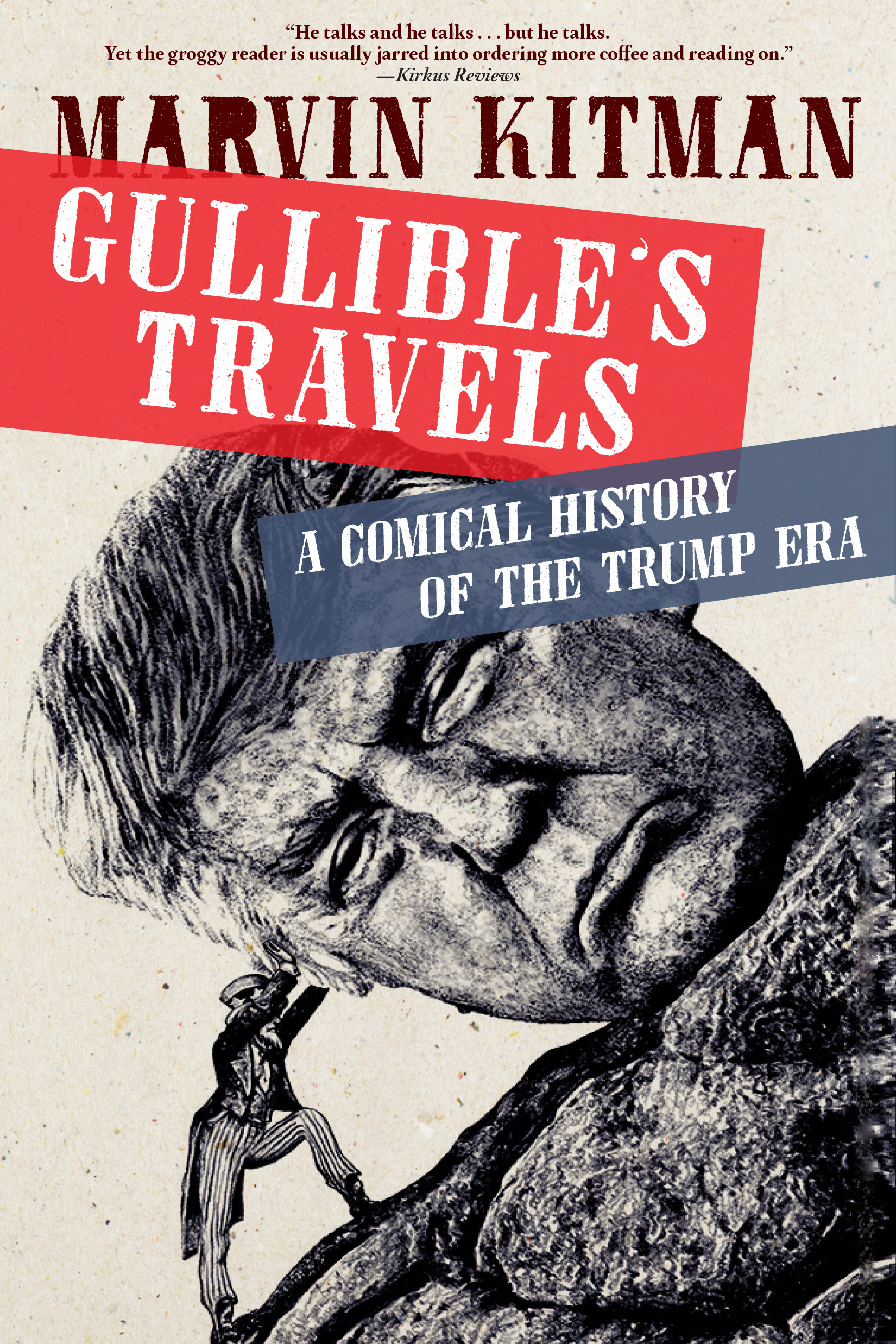
Gullible's Travels How to have fun hating Trump Kitman describes the land of Gulliblesylvania as a democratic country ruled by 34.9 % of the people, "a minority better known as 'the base,' of whom a candidate said he could shoot someone on Fifth Avenue and they would still vote for him." At first Kitman assumed that Trump's candidacy was a publicity stunt. After he realized it was serious, as a satirist he felt very lucky and began to keep a comical journal, modeled after A Journal of the Plague Year which Daniel Defoe described as "Observations of the most remarkable occurrence, which happened in London during the last great visitation in 1665"--which is not to compare the Trump administration to the bubonic plague, Kitman hastens to add. "For one thing, as our POTUS has been telling us, he's made America Great again--AND IT ONLY TOOK A YEAR AND A HALF!" Kitman adds, "And I have never before had such a good time observing and writing about the follies of our country." Gullibles Travels includes 32 "Trumponicles; the debate over the president's intellectual capacity; "That Russian Thing;" "Who is Agent Orange"; and a CODA that asks the question, "How Will It All End?" Impeachment? 25th Amendment sacking? Resignation? Or reelection? POLITICAL SCIENCE,American Government,Executive Branch
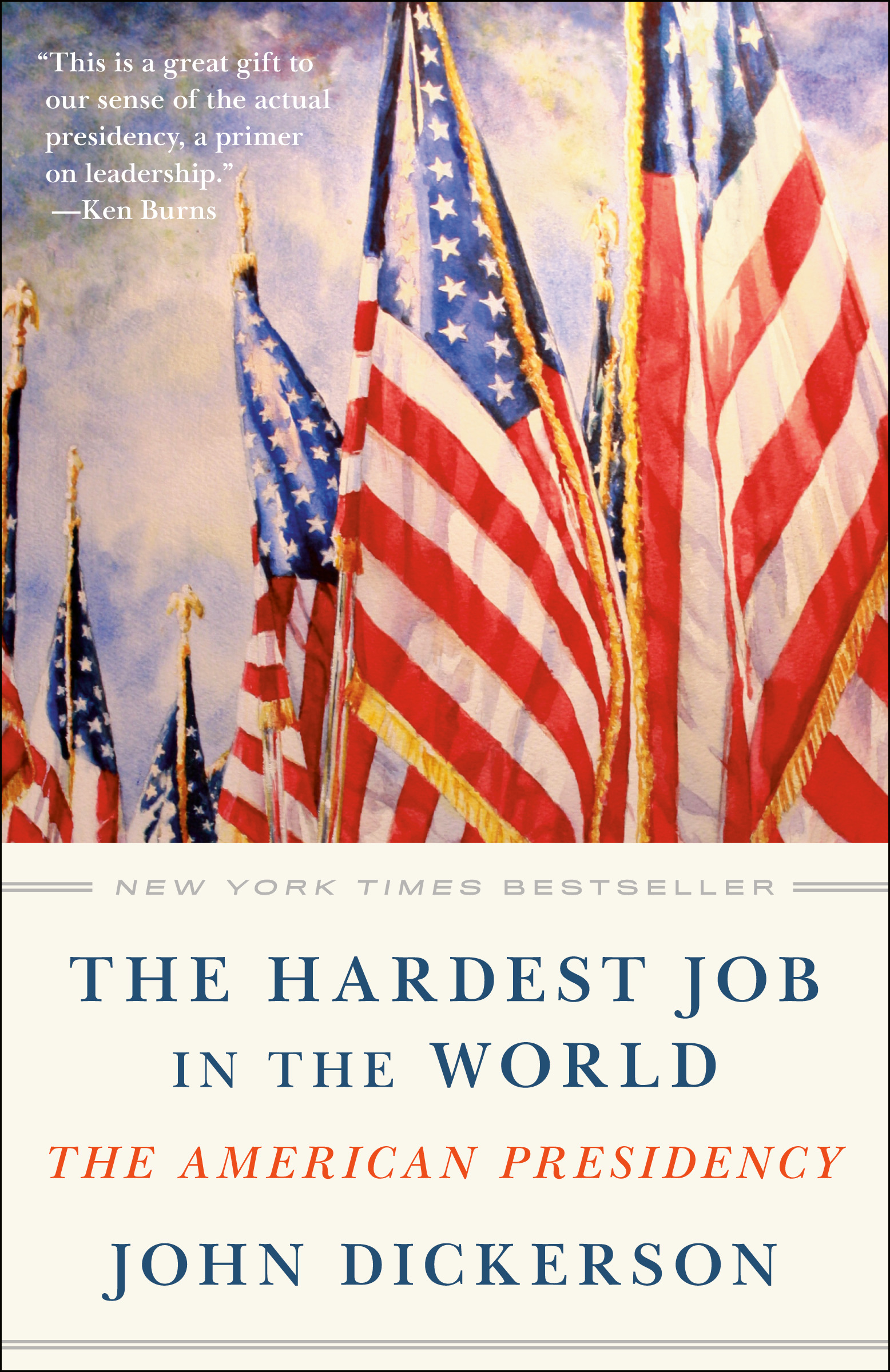
The Hardest Job in the World NEW YORK TIMES BESTSELLER • From the veteran political journalist and 60 Minutes correspondent, a deep dive into the history, evolution, and current state of the American presidency—and how we can make the job less impossible and more productive. “This is a great gift to our sense of the actual presidency, a primer on leadership.”—Ken Burns Imagine you have just been elected president. You are now commander-in-chief, chief executive, chief diplomat, chief legislator, chief of party, chief voice of the people, first responder, chief priest, and world leader. You’re expected to fulfill your campaign promises, but you’re also expected to solve the urgent crises of the day. What’s on your to-do list? Where would you even start? What shocks aren’t you thinking about? The American presidency is in trouble. It has become overburdened, misunderstood, almost impossible to do. “The problems in the job unfolded before Donald Trump was elected, and the challenges of governing today will confront his successors,” writes John Dickerson. After all, the founders never intended for our system of checks and balances to have one superior Chief Magistrate, with Congress demoted to “the little brother who can’t keep up.” In this eye-opening book, John Dickerson writes about presidents in history such a Washington, Lincoln, FDR, and Eisenhower, and and in contemporary times, from LBJ and Reagan and Bush, Obama, and Trump, to show how a complex job has been done, and why we need to reevaluate how we view the presidency, how we choose our presidents, and what we expect from them once they are in office. Think of the presidential campaign as a job interview. Are we asking the right questions? Are we looking for good campaigners, or good presidents? Once a candidate gets the job, what can they do to thrive? Drawing on research and interviews with current and former White House staffers, Dickerson defines what the job of president actually entails, identifies the things that only the president can do, and analyzes how presidents in history have managed the burden. What qualities make for a good president? Who did it well? Why did Bill Clinton call the White House “the crown jewel in the American penal system”? The presidency is a job of surprises with high stakes, requiring vision, management skill, and an even temperament. Ultimately, in order to evaluate candidates properly for the job, we need to adjust our expectations, and be more realistic about the goals, the requirements, and the limitations of the office. As Dickerson writes, “Americans need their president to succeed, but the presidency is set up for failure. It doesn’t have to be.” POLITICAL SCIENCE,American Government,Executive Branch
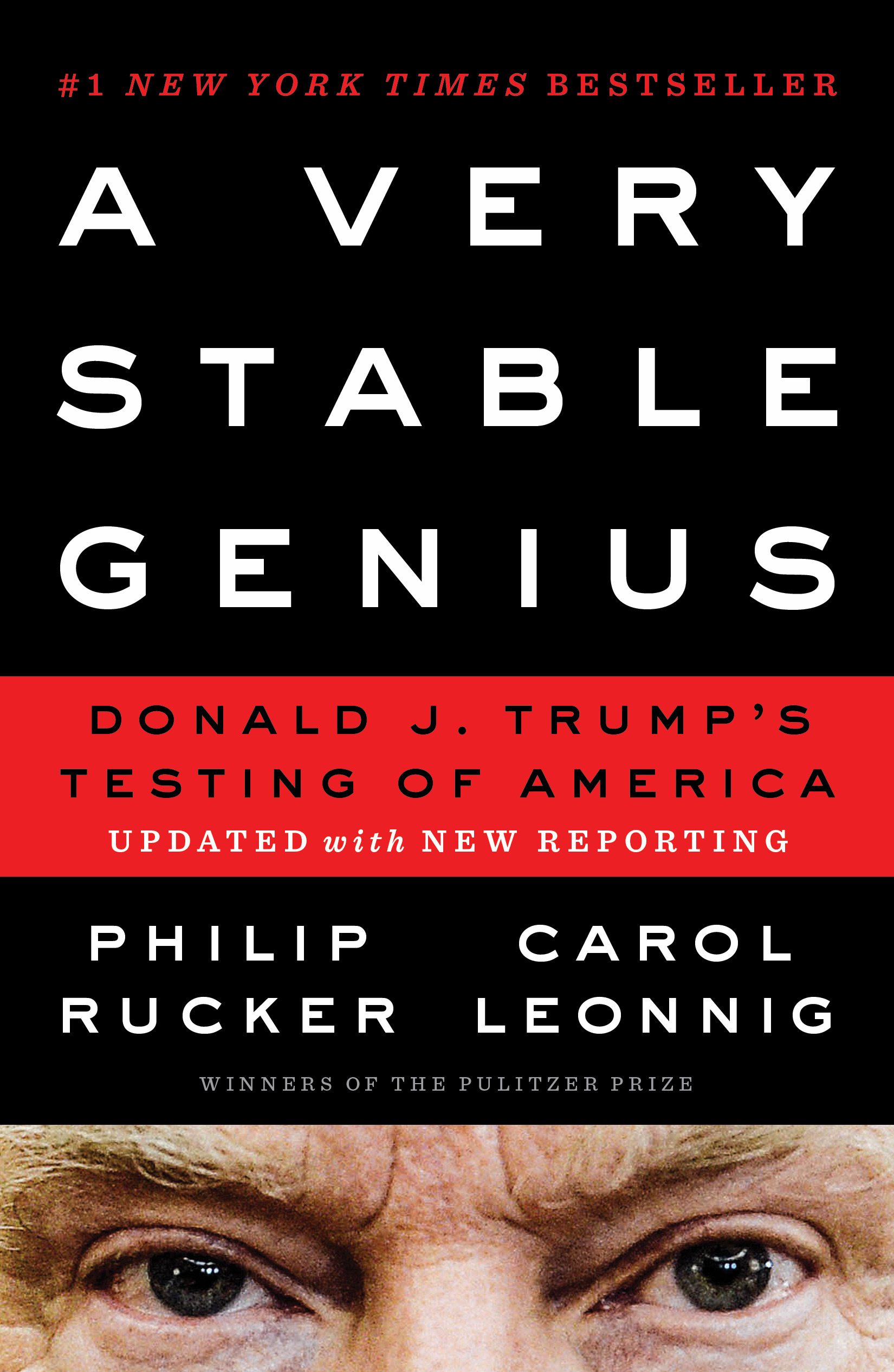
A Very Stable Genius The instant #1 bestseller. “This taut and terrifying book is among the most closely observed accounts of Donald J. Trump’s shambolic tenure in office to date." - Dwight Garner, The New York Times Washington Post national investigative reporter Carol Leonnig and White House bureau chief Philip Rucker, both Pulitzer Prize winners, provide the definitive insider narrative of Donald Trump's unique presidency with shocking new reporting and insight into its implications. “I alone can fix it.” So went Donald J. Trump’s march to the presidency on July 21, 2016, when he accepted the Republican presidential nomination in Cleveland, promising to restore what he described as a fallen nation. Yet over the subsequent years, as he has undertaken the actual work of the commander in chief, it has been hard to see beyond the daily chaos of scandal, investigation, and constant bluster. It would be all too easy to mistake Trump’s first term for one of pure and uninhibited chaos, but there were patterns to his behavior and that of his associates. The universal value of the Trump administration is loyalty - not to the country, but to the president himself - and Trump’s North Star has been the perpetuation of his own power, even when it meant imperiling our shaky and mistrustful democracy. Leonnig and Rucker, with deep and unmatched sources throughout Washington, D.C., tell of rages and frenzies but also moments of courage and perseverance. Relying on scores of exclusive new interviews with some of the most senior members of the Trump administration and other firsthand witnesses, the authors reveal the forty-fifth president up close, taking readers inside Robert Mueller’s Russia investigation as well as the president’s own haphazard but ultimately successful legal defense. Here for the first time certain officials who have felt honor-bound not to publicly criticize a sitting president or to divulge what they witnessed in a position of trust tell the truth for the benefit of history. This peerless and gripping narrative reveals President Trump at his most unvarnished and exposes how decision making in his administration has been driven by a reflexive logic of self-preservation and self-aggrandizement - but a logic nonetheless. This is the story of how an unparalleled president has scrambled to survive and tested the strength of America’s democracy and its common heart as a nation. POLITICAL SCIENCE,American Government,Executive Branch

Profiles in Corruption NEW YORK TIMES BESTSELLER Washington insiders operate by a proven credo: when a Peter Schweizer book drops, duck and brace for impact. For over a decade, the work of five-time New York Times bestselling investigative reporter Peter Schweizer has sent shockwaves through the political universe. Clinton Cash revealed the Clintons’ international money flow, exposed global corruption, and sparked an FBI investigation. Secret Empires exposed bipartisan corruption and launched congressional investigations. And Throw Them All Out and Extortion prompted passage of the STOCK Act. Indeed, Schweizer’s “follow the money†bombshell revelations have been featured on the front pages of the New York Times and the Wall Street Journal, and regularly appear on national news programs, including 60 Minutes. Now Schweizer and his team of seasoned investigators turn their focus to the nation’s top progressives—politicians who strive to acquire more government power to achieve their political ends. Can they be trusted with more power? In Profiles in Corruption, Schweizer offers a deep-dive investigation into the private finances, and secrets deals of some of America’s top political leaders. And, as usual, he doesn’t disappoint, with never-before-reported revelations that uncover corruption and abuse of power—all backed up by a mountain of corporate documents and legal filings from around the globe. Learn about how they are making sweetheart deals, generating side income, bending the law to their own benefits, using legislation to advance their own interests, and much more. Profiles in Corruption contains tomorrow’s headlines. POLITICAL SCIENCE,American Government,Executive Branch

The Powers of the Presidency Providing both a historical and contemporary perspective on presidential powers, The Powers of the Presidency guides readers through the presidency as a constitutional office, covering how it was shaped by design at the Constitutional Convention in 1787 and by later constitutional amendments, Supreme Court decisions, and custom and precedent. It discusses the various roles of the chief executive, including chief of state, chief administrator, legislative leader, chief diplomat, commander in chief, and chief economist. The fourth edition of this accessible and affordable work has been significantly updated and features: · Coverage of the final years of George W. Bush and the first three years of Barack Obama's presidency · Extensive coverage of the Obama Administration's efforts to curb economic decline · Updates on the wars in Iraq and Afghanistan, the killing of Osama bin Laden, and on the treatment of detainees at Guantanamo Bay · Coverage of the Arab Spring protests and U.S. involvement in the military intervention in Libya · Barack Obama's health care reform legislation POLITICAL SCIENCE,American Government,Executive Branch

The Politics of the Presidency Trace the opening rounds of the Trump administration: highlighting the 2016 election, transition, inauguration, and first one hundred days. Never losing sight of the foundations of the office, The Politics of the Presidency maintains a balance between historical context, the current political environment, and contemporary scholarship on the executive branch, providing a solid foundation for any presidency course. In addition to offering you a comprehensive framework for understanding the expectations, powers, and limitations of the executive branch, the Revised Ninth Edition uses the most up-to-date coverage and analysis of the 2016 election and Trump administration to demonstrate key concepts. New to the Revised Ninth Edition: A new chapter dedicated to the Trump transition and first one hundred days examines important topics such as the immigration ban and other executive orders; efforts at deregulation; the targeted military strikes in Syria; and the war on the intelligence community and the deconstruction of the administrative state. Recent congressional relations analyzed, including the confirmation of Supreme Court justice Neil Gorsuch after Senate Republicans employed the “nuclear option†and took away the opportunity to filibuster Supreme Court nominees; efforts to repeal and replace Obamacare; fiscal 2017 and 2018 budget negotiations; and congressional investigations of the Trump campaign’s ties to Russia, his firing of FBI director James Comey, and the appointment of a special counsel in the matter. An assessment of the public presidency reviews Trump’s approval ratings, communications strategies, and media coverage. Discussions of Trump’s leadership challenges in a polarized age explain the difficulties of unifying a nation after a bitter election, launching an administration, and structuring the executive branch. POLITICAL SCIENCE,American Government,Executive Branch
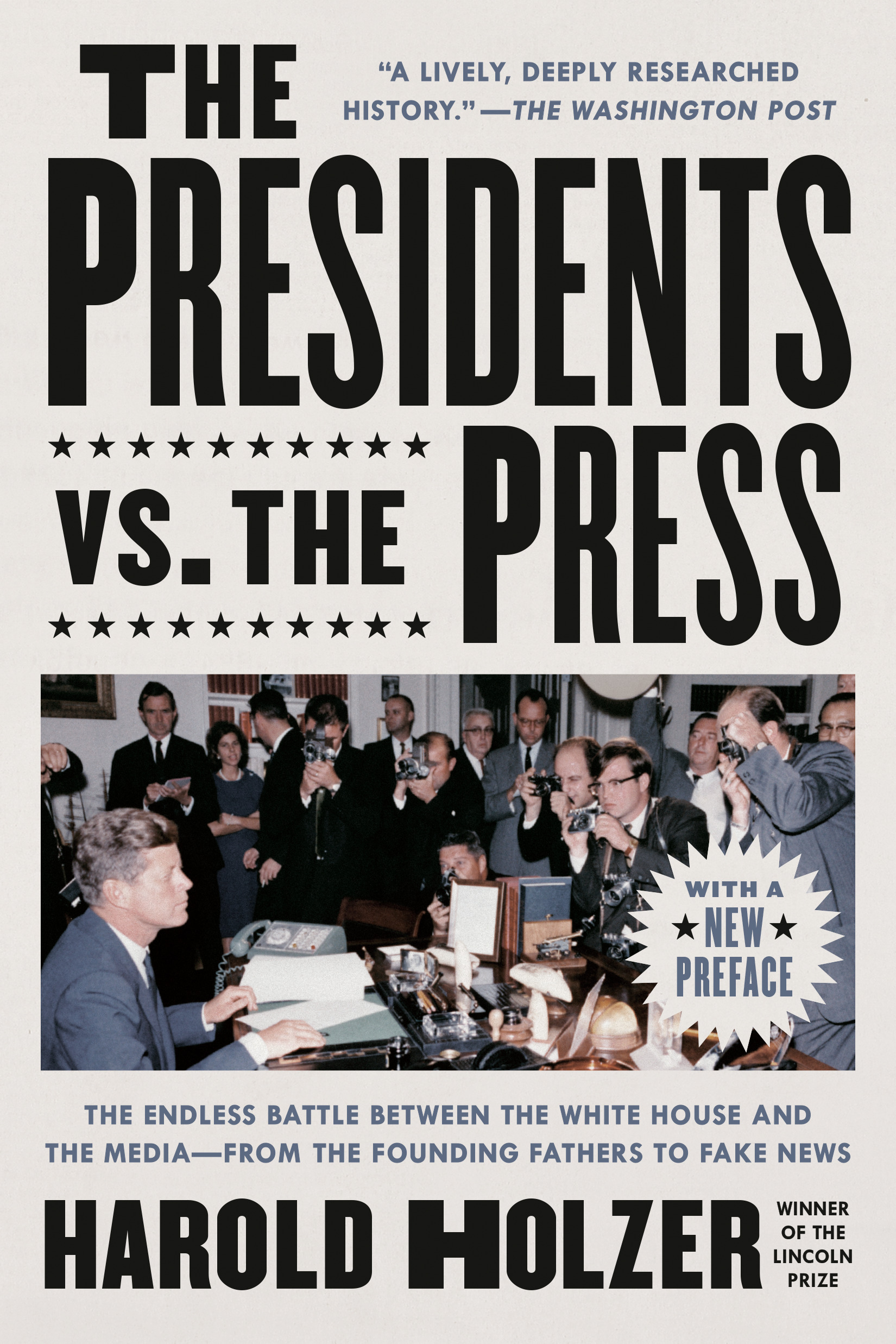
The Presidents vs. the Press An award-winning presidential historian offers an authoritative account of American presidents' attacks on our freedom of the press. “The FAKE NEWS media,” Donald Trump has tweeted, “is not my enemy, it is the enemy of the American People!” Has our free press ever faced as great a threat? Perhaps not—but the tension between presidents and journalists is as old as the republic itself. Every president has been convinced of his own honesty and transparency; every reporter who has covered the White House beat has believed with equal fervency that his or her journalistic rigor protects the country from danger. Our first president, George Washington, was also the first to grouse about his treatment in the newspapers, although he kept his complaints private. Subsequent chiefs like John Adams, Abraham Lincoln, Woodrow Wilson, and Barack Obama were not so reticent, going so far as to wield executive power to overturn press freedoms, and even to prosecute journalists. Theodore Roosevelt was the first president to actively manage the stable of reporters who followed him, doling out information, steering coverage, and squashing stories that interfered with his agenda. It was a strategy that galvanized TR’s public support, but the lesson was lost on Woodrow Wilson, who never accepted reporters into his inner circle. Franklin Roosevelt transformed media relations forever, holding more than a thousand presidential press conferences and harnessing the new power of radio, at times bypassing the press altogether. John F. Kennedy excelled on television and charmed reporters to hide his personal life, while Richard Nixon was the first to cast the press as a public enemy. From the days of newsprint and pamphlets to the rise of Facebook and Twitter, each president has harnessed the media, whether intentional or not, to imprint his own character on the office. In this remarkable new history, acclaimed scholar Harold Holzer examines the dual rise of the American presidency and the media that shaped it. From Washington to Trump, he chronicles the disputes and distrust between these core institutions that define the United States of America, revealing that the essence of their confrontation is built into the fabric of the nation. POLITICAL SCIENCE,American Government,Executive Branch

A Warning #1 New York Times and #1 Wall Street Journal bestseller: An unprecedented behind-the-scenes portrait of the Trump presidency from the anonymous senior official whose first words of warning about the president rocked the nation's capital. On September 5, 2018, the New York Times published a bombshell essay and took the rare step of granting its writer anonymity. Described only as "a senior official in the Trump administration," the author provided eyewitness insight into White House chaos, administration instability, and the people working to keep Donald Trump's reckless impulses in check. With the 2020 election on the horizon, Anonymous is speaking out once again. In this book, the original author pulls back the curtain even further, offering a first-of-its-kind look at the president and his record -- a must-read before Election Day. It will surprise and challenge both Democrats and Republicans, motivate them to consider how we judge our nation's leaders, and illuminate the consequences of re-electing a commander in chief unfit for the role. This book is a sobering assessment of the man in the Oval Office and a warning about something even more important -- who we are as a people. POLITICAL SCIENCE,American Government,Executive Branch
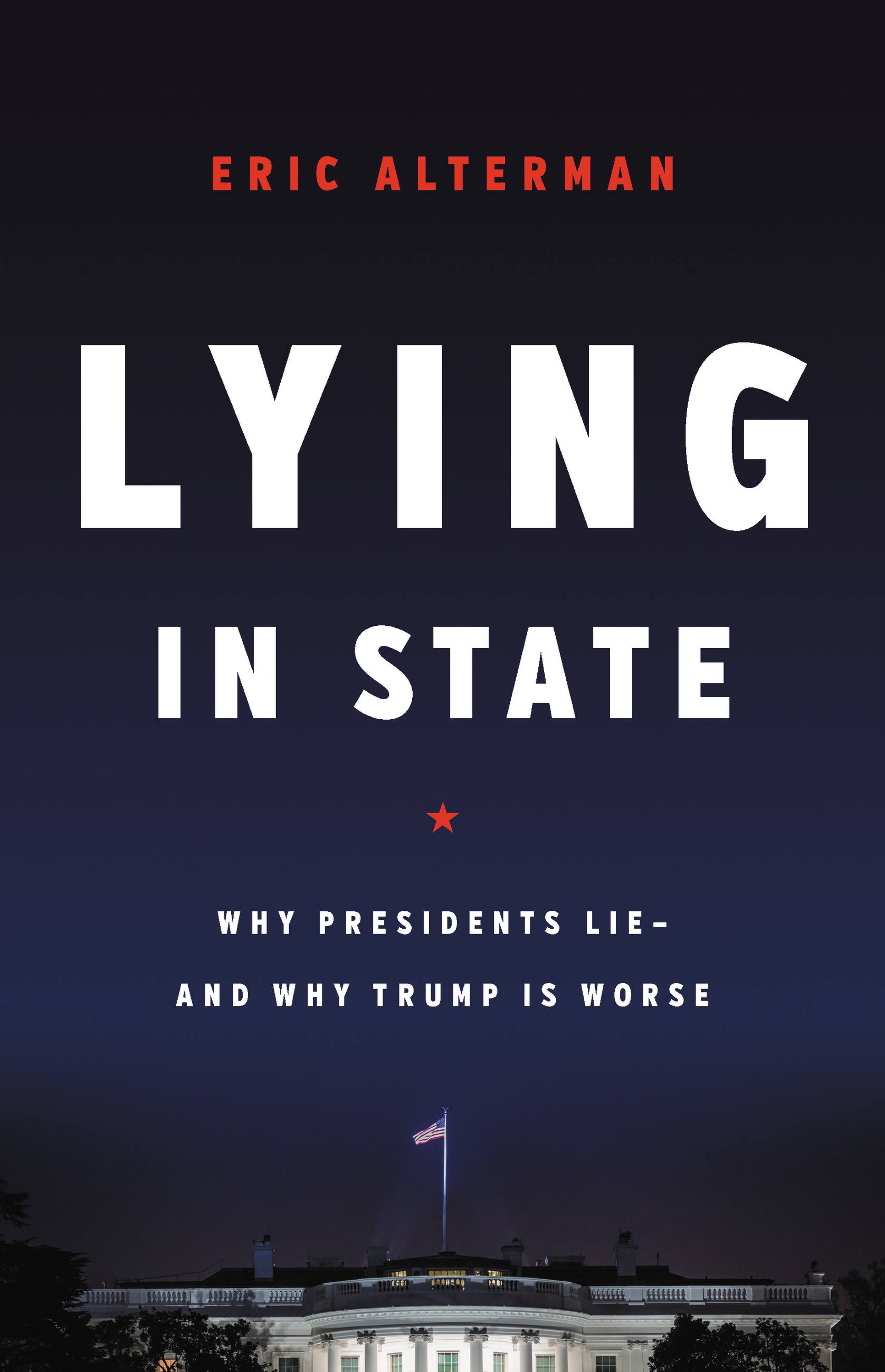
Lying in State This definitive history of presidential lying reveals how our standards for truthfulness have eroded -- and why Trump's lies are especially dangerous. If there's one thing we know about Donald Trump, it's that he lies. But he's by no means the first president to do so. In Lying in State, Eric Alterman asks how we ended up with such a pathologically dishonest commander in chief, showing that, from early on, the United States has persistently expanded its power and hegemony on the basis of presidential lies. He also reveals the cumulative effect of this deception-each lie a president tells makes it more acceptable for subsequent presidents to lie-and the media's complicity in spreading misinformation. Donald Trump, then, represents not an aberration but the culmination of an age-old trend. Full of vivid historical examples and trenchant analysis, Lying in State is essential reading for anyone seeking to understand how we arrived in this age of alternative facts. POLITICAL SCIENCE,American Government,Executive Branch

Hoax INSTANT NEW YORK TIMES BESTSELLER “A thorough and damning exploration of the incestuous relationship between Trump and his favorite channel.†—The New York Times “A Rosetta Stone for stuff about this presidency that doesn’t otherwise make sense to normal humans.†—Rachel Maddow, MSNBC “Stelter’s critique goes beyond salacious tidbits about extramarital affairs (though there are plenty of those) to expose a collusion that threatens the pillars of our democracy.†—The Washington Post The urgent and untold story of the collusion between Fox News and Donald Trump from the New York Times bestselling author of Top of the Morning. While other leaders were marshaling resources to combat the greatest pandemic in modern history, President Donald Trump was watching TV. Trump watches over six hours of Fox News a day, a habit his staff refers to as “executive time.†In January 2020, when Fox News began to downplay COVID-19, the President was quick to agree. In March, as the deadly virus spiraled out of control, Sean Hannity mocked “coronavirus hysteria†as a “new hoax†from the left. Millions of Americans took Hannity and Trump's words as truth—until some of them started to get sick. In Hoax, CNN anchor and chief media correspondent Brian Stelter tells the twisted story of the relationship between Donald Trump and Fox News. From the moment Trump glided down the golden escalator to announce his candidacy in the 2016 presidential election to his acquittal on two articles of impeachment in early 2020, Fox hosts spread his lies and smeared his enemies. Over the course of two years, Stelter spoke with over 250 current and former Fox insiders in an effort to understand the inner workings of Rupert Murdoch's multibillion-dollar media empire. Some of the confessions are alarming. “We don't really believe all this stuff,†a producer says. “We just tell other people to believe it.†At the center of the story lies Sean Hannity, a college dropout who, following the death of Fox News mastermind Roger Ailes, reigns supreme at the network that pays him $30 million a year. Stelter describes the raging tensions inside Fox between the Trump loyalists and the few remaining journalists. He reveals why former chief news anchor Shep Smith resigned in disgust in 2019; why a former anchor said “if I stay here I’ll get cancer;†and how Trump has exploited the leadership vacuum at the top to effectively seize control of the network. Including never before reported details, Hoax exposes the media personalities who, though morally bankrupt, profit outrageously by promoting the President’s propaganda and radicalizing the American right. It is a book for anyone who reads the news and wonders: How did this happen? POLITICAL SCIENCE,American Government,Executive Branch

Defender in Chief In Defender in Chief, celebrated constitutional scholar John Yoo makes a provocative case against Donald Trump's alleged disruption of constitutional rules and norms. Donald Trump isn't shredding the Constitution—he's its greatest defender. Ask any liberal—and many moderate conservatives—and they'll tell you that Donald Trump is a threat to the rule of law and the U.S. Constitution. Mainstream media outlets have reported fresh examples of alleged executive overreach or authoritarian White House decisions nearly every day of his presidency. In the 2020 primaries, the candidates have rushed to accuse Trump of destroying our democracy and jeopardizing our nation's very existence. Yoo argues that this charge has things exactly backwards. Far from considering Trump an inherent threat to our nation's founding principles, Yoo convincingly argues that Washington, Jefferson, Madison and Hamilton would have seen Trump as returning to their vision of presidential power, even at his most controversial. It is instead liberal opponents who would overthrow existing constitutional understanding in order to unseat Trump, but in getting their man would inflict permanent damage on the office of the presidency, the most important office in our constitutional system and the world. This provocative and engaging work is a compelling defense of an embattled president's ideas and actions. POLITICAL SCIENCE,American Government,Executive Branch
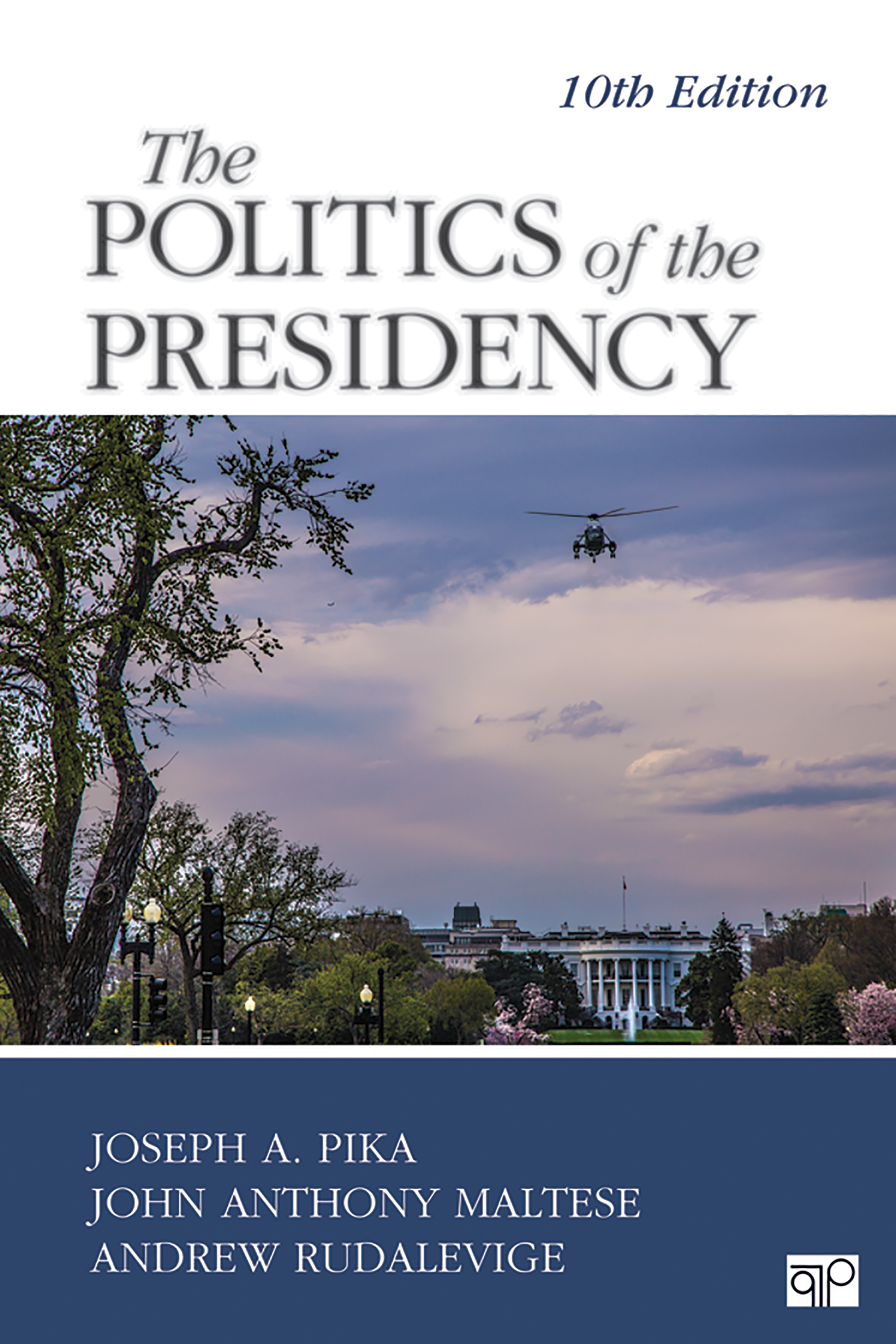
The Politics of the Presidency The most up-to-date coverage and analysis of the presidency Never losing sight of the foundations of the political office, The Politics of the Presidency maintains a balance between historical context and contemporary scholarship on the executive branch, providing a solid foundation for any presidency course. In the highly anticipated Tenth Edition of this bestseller, Pika, Maltese, and Rudalevige thoroughly analyze the change and continuity in the presidency during President Trump's first term, his relations with Congress and the judiciary, the outcomes of the 2018 midterm election, and the competitive setting for the 2020 presidential race. POLITICAL SCIENCE,American Government,Executive Branch
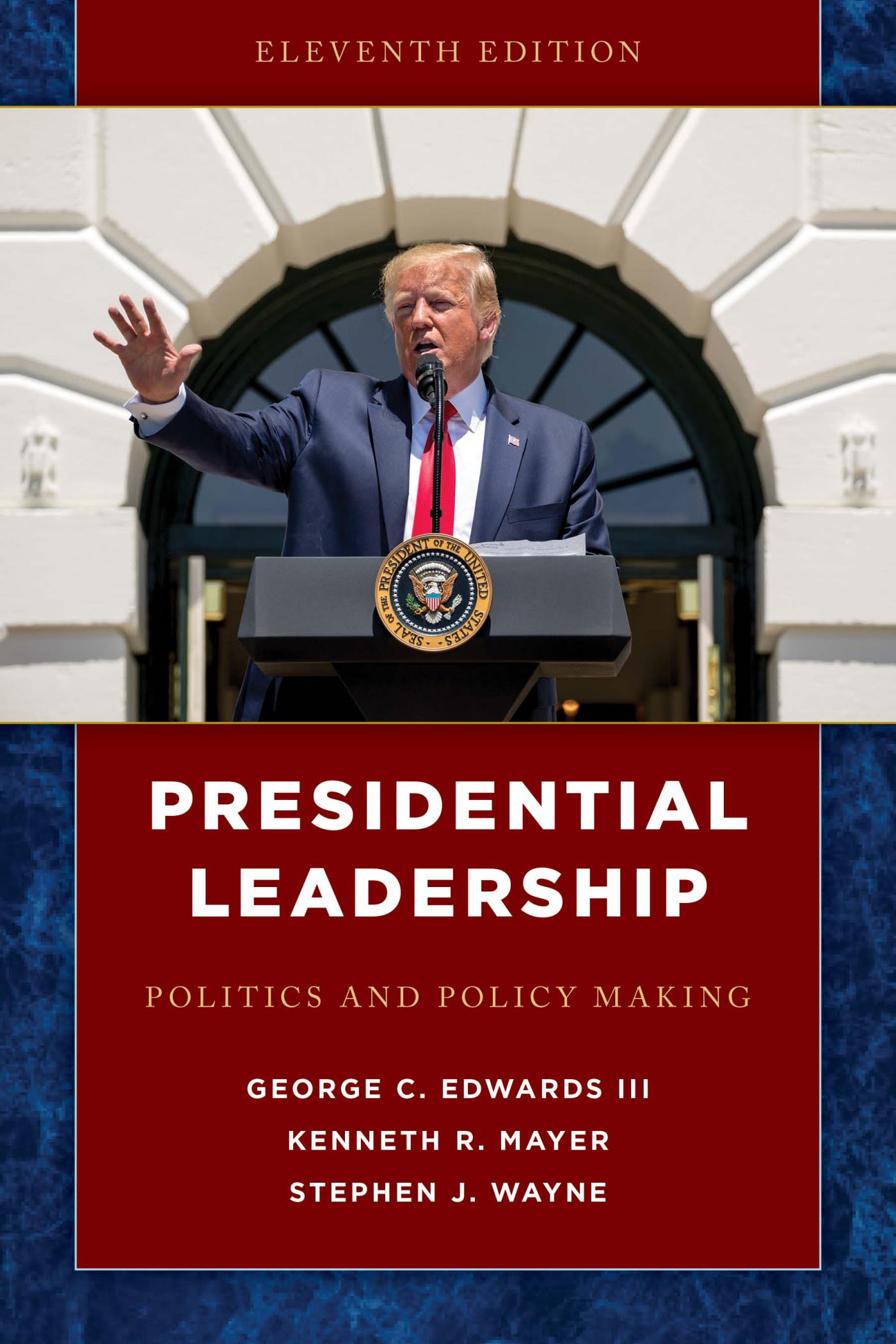
Presidential Leadership With a focus on presidential leadership, Edwards, Mayer and Wayne address the capacity of chief executives to fulfill their tasks, exercise their powers, and utilize their organizational structures to affect the output of government. Richly illustrated with timely, fascinating examples, this text examines all aspects of the presidency. POLITICAL SCIENCE,American Government,Executive Branch

50 Things They Don't Want You to Know About Trump Breitbart.com editor Jerome Hudson returns with even more red pills, facts, and statistics to counteract the lies and blind spots of the mainstream media. Did you know Donald Trump has allocated more funding to historically black colleges and universities than any other president? In 50 Things They Don’t Want You to Know About Trump, Jerome Hudson uncovers all the things Americans have not been told about our 45th president. We’re surrounded by supposed influencers shouting about the scandals that Americans care about the least, from TV talking heads to social media activists, from feckless Washington swamp monsters to candidates fighting for the soap box. Your teachers, your politicians, and your local paper are not likely to ever tell you: Drug overdoses dropped for the first time in 30 years under Trump. America once again led the world in reducing carbon emissions in 2019. Trump is the first pro-gay marriage candidate elected president. (Obama endorsed it after his election.) Democrats backed out of attending an award ceremony from a criminal justice reform organization when they found out Trump won the award. The famous "Muslim ban" excluded 87 percent of the world's Muslims. Under Trump, blue-collar workers enjoyed three-times the wage growth of the top 1-percent of households. After finishing 50 Things They Don’t Want You to Know About Trump, you’ll be stunned at the many Trump accomplishments which just aren’t reported by the powers that be. POLITICAL SCIENCE,American Government,Executive Branch

Battlegrounds From Lt. General H.R. McMaster, U.S. Army, ret., the former National Security Advisor and author of the bestselling classic Dereliction of Duty, comes a bold and provocative re-examination of the most critical foreign policy and national security challenges that face the United States, and an urgent call to compete to preserve America’s standing and security. Across multiple administrations since the end of the Cold War, American foreign policy has been misconceived, inconsistent, and poorly implemented. As a result, America and the free world have fallen behind rivals in power and influence. Meanwhile threats to security, freedom, and prosperity, such as nuclear proliferation and jihadist terrorism have grown. In BATTLEGROUNDS, H.R. McMaster describes efforts to reassess and fundamentally shift policies while he was National Security Advisor. And he provides a clear pathway forward to improve strategic competence and prevail in complex competitions against our adversaries. BATTLEGROUNDS is a groundbreaking reassessment of America’s place in the world, drawing from McMaster’s long engagement with these issues, including 34 years of service in the U.S. Army with multiple tours of duty in battlegrounds overseas and his 13 months as National Security Advisor in the Trump White House. It is also a powerful call for Americans and citizens of the free world to transcend the vitriol of partisan political discourse, better educate themselves about the most significant challenges to national and international security and work together to secure peace and prosperity for future generations. POLITICAL SCIENCE,American Government,Executive Branch

High Crimes Two award-winning journalists offer the most comprehensive inside story behind our most significant modern political drama: the House impeachment of Donald Trump. Having spent a year essentially embedded inside several House committees, Michael D'Antonio and Peter Eisner draw on many sources, including key House leaders, to expose the politicking, playcalling, and strategies debated backstage and to explain the Democrats' successes and apparent public failures during the show itself. High Crimes opens with Nancy Pelosi deciding the House should take up impeachment, then, in part one, leaps back to explain what Ukraine was really all about: not just Joe Biden and election interference, but a money grab and oil. In the second part, the authors recount key meetings throughout the run up to the impeachment hearings, including many of the heated confrontations between the Trump administration and House Democrats. And the third part takes readers behind the scenes of those hearings, showing why certain things happened the way they did for reasons that never came up in public. In the end, having illuminated every step of impeachment, from the schemes that led Giuliani to the Ukraine in 2016 to Fiona Hill's rebuking the Republicans' conspiracy theories, High Crimes promises to be Trump's Final Days. POLITICAL SCIENCE,American Government,Executive Branch

The Room Where It Happened As President Trump’s National Security Advisor, John Bolton spent many of his 453 days in the room where it happened, and the facts speak for themselves. The result is a White House memoir that is the most comprehensive and substantial account of the Trump Administration, and one of the few to date by a top-level official. With almost daily access to the President, John Bolton has produced a precise rendering of his days in and around the Oval Office. What Bolton saw astonished him: a President for whom getting reelected was the only thing that mattered, even if it meant endangering or weakening the nation. “I am hard-pressed to identify any significant Trump decision during my tenure that wasn’t driven by reelection calculations,†he writes. In fact, he argues that the House committed impeachment malpractice by keeping their prosecution focused narrowly on Ukraine when Trump’s Ukraine-like transgressions existed across the full range of his foreign policy—and Bolton documents exactly what those were, and attempts by him and others in the Administration to raise alarms about them. He shows a President addicted to chaos, who embraced our enemies and spurned our friends, and was deeply suspicious of his own government. In Bolton’s telling, all this helped put Trump on the bizarre road to impeachment. “The differences between this presidency and previous ones I had served were stunning,†writes Bolton, who worked for Reagan, Bush 41, and Bush 43. He discovered a President who thought foreign policy is like closing a real estate deal—about personal relationships, made-for-TV showmanship, and advancing his own interests. As a result, the US lost an opportunity to confront its deepening threats, and in cases like China, Russia, Iran, and North Korea ended up in a more vulnerable place. Bolton’s account starts with his long march to the West Wing as Trump and others woo him for the National Security job. The minute he lands, he has to deal with Syria’s chemical attack on the city of Douma, and the crises after that never stop. As he writes in the opening pages, “If you don’t like turmoil, uncertainty, and risk—all the while being constantly overwhelmed with information, decisions to be made, and sheer amount of work—and enlivened by international and domestic personality and ego conflicts beyond description, try something else.†The turmoil, conflicts, and egos are all there—from the upheaval in Venezuela, to the erratic and manipulative moves of North Korea’s Kim Jong Un, to the showdowns at the G7 summits, the calculated warmongering by Iran, the crazy plan to bring the Taliban to Camp David, and the placating of an authoritarian China that ultimately exposed the world to its lethal lies. But this seasoned public servant also has a great eye for the Washington inside game, and his story is full of wit and wry humor about how he saw it played. POLITICAL SCIENCE,American Government,Executive Branch
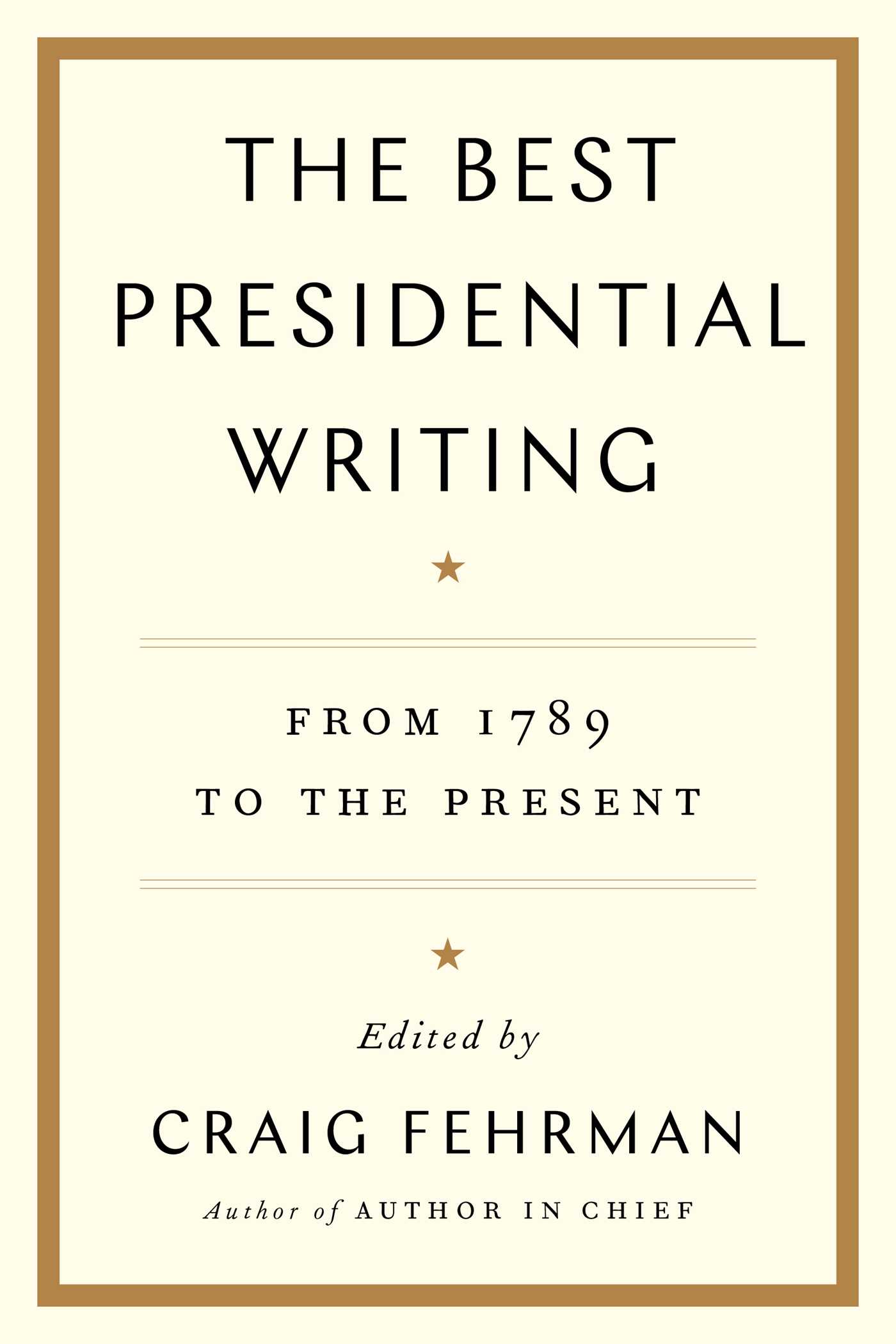
The Best Presidential Writing A sweeping, groundbreaking, and comprehensive treasury of the most essential presidential writings, featuring a richly varied mix of the beloved and the little-known, from stirring speeches and shrewd remarks to behind-the-scenes drafts and unpublished autobiographies. From the early years of our nation’s history, when George Washington wrote his humble yet powerful Farewell Address, to our current age, when Barack Obama delivered his moving speech on the fiftieth anniversary of the Selma-to-Montgomery marches, America’s presidents have upheld a tradition of exceptional writing. Now, for the first time, the greatest presidential writings in history are united in one monumental treasury: the very best campaign orations, early autobiographies, presidential speeches, postpresidential reflections, and much more. In these pages, we see not only the words that shaped our nation, like Abraham Lincoln’s Emancipation Proclamation and Franklin D. Roosevelt’s Infamy speech, but also the words of young politicians claiming their place in our history, including excerpts from Woodrow Wilson’s Congressional Government and Obama’s career-making convention speech, and the words of mature leaders reflecting on their legacies, including John Adam’s autobiography and Harry S. Truman’s Memoirs. We even see hidden sides of the presidents that the public rarely glimpses: noted outdoorsman Teddy Roosevelt’s great passion for literature or sunny Ronald Reagan’s piercing childhood memories of escorting home his alcoholic father. Encompassing notable favorites like Lincoln’s Gettysburg Address and John F. Kennedy’s Inaugural Address as well as lesser-known texts like Thomas Jefferson’s Notes on the State of Virginia and James Polk’s candid White House diary, The Best Presidential Writing showcases America’s presidents as thinkers, citizens, and leaders. More than simply a curation of must-read presidential writings, this unique collection presents the story of America itself, told by its highest leaders. What is America? Who is America for? What will America become? Since our nation’s founding, different presidents have offered different answers. In their writings, we see frontiers expand, ideals transform, and novel ideas take root. Even the most famous speeches find new meanings or fresh connections when read in this sweeping context, making The Best Presidential Writing a trove full of insight and an essential historical document. POLITICAL SCIENCE,American Government,Executive Branch

On Impeachment A short, accessible collection of key historic writings about presidential impeachment, as part of a new Penguin Classics series on liberty and constitutional rights. A Penguin Classic Penguin Liberty is a newly curated series of historical, political and legal classic texts from Penguin Classics. One of the first volumes, On Impeachment, provides key historic writings to understand what impeachment is and learn about three presidents who have been subject to the process: Andrew Johnson, Richard Nixon and Bill Clinton. The volume includes essential texts from each of the two presidential impeachments that were voted by the House, and the Nixon case, which was voted on by the House judiciary committee and which forced Nixon's resignation. Readers will have a scope of perspectives from the Constitution, George Washington, Alexander Hamilton, Frederick Douglass, Barbara Jordan, Gerald Ford, Dianne Feinstein, and more. Each volume will feature a series introduction and volume introduction by series editor Corey Brettschneider. POLITICAL SCIENCE,American Government,Executive Branch
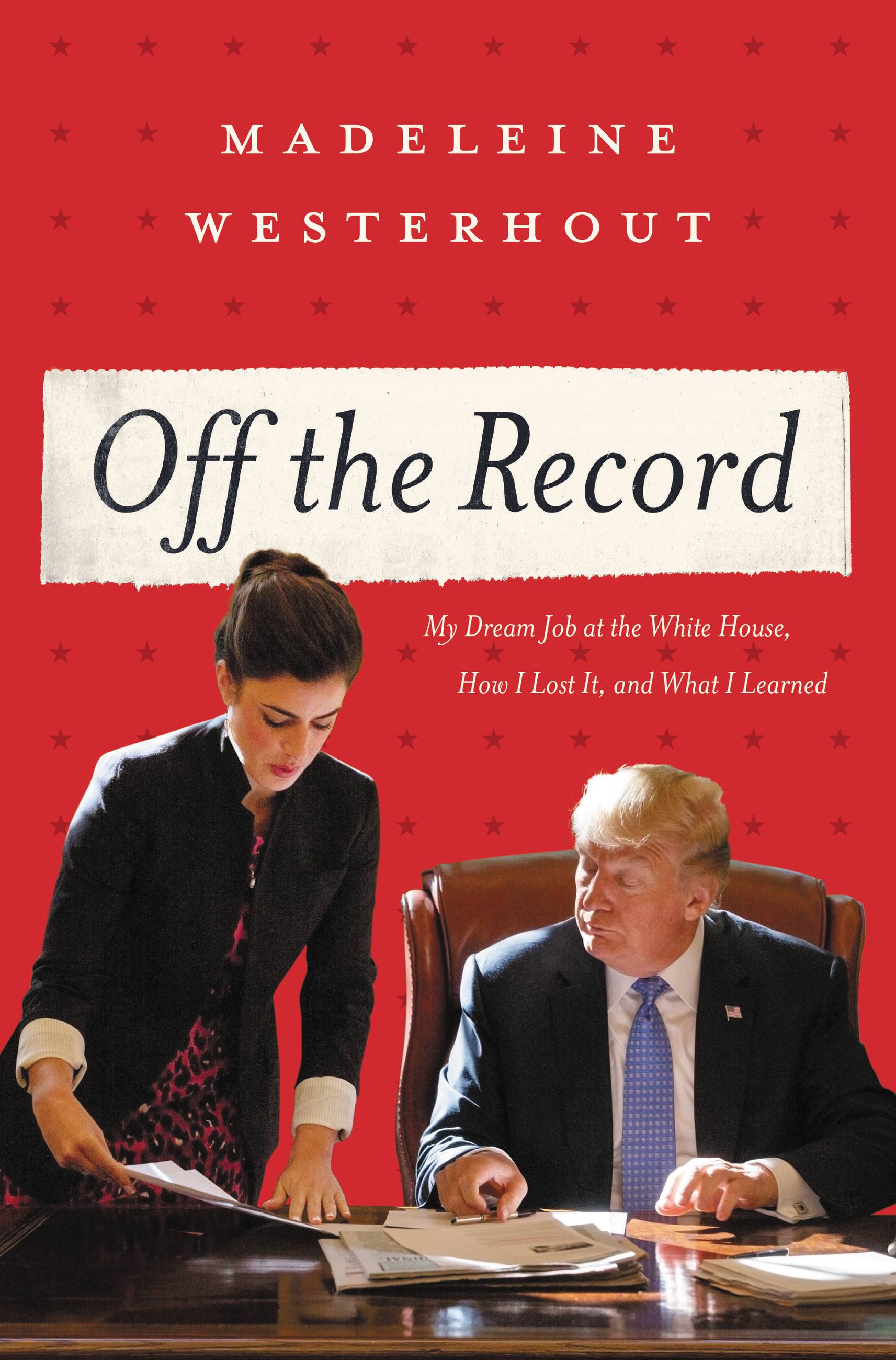
Off the Record Madeleine Westerhout, the former "gatekeeper" of the Trump White House, writes about her relationship with the president, and tells the story of the terrible mistake that led to her losing her job. From the first day President Trump stepped into the White House, Madeleine Westerhout was by his side, first as his executive assistant, then as the Director of Oval Office Operations. From her desk outside the Oval, she saw everyone who came in to see the president. She placed his phone calls, and was in the room for several historic moments. During her time working with President Trump at the White House, Camp David, Mar a Lago, and Bedminster, she grew to love her job and admire the president. Then, in an unguarded moment during a dinner with reporters, she made a terrible mistake. In Off the Record, Westerhout tells the full story of this dinner for the first time, revealing the circumstances that led to her fateful mistake. She also writes about her relationship with President Trump -- all the lessons she learned working with him, and why she believes he is a much different man than the one the media portrays every day. Westerhout describes President Trump as a kind and generous boss who continues to be a great leader for our country. POLITICAL SCIENCE,American Government,Executive Branch

The Tweets of President Donald J. Trump Love them or hate them, the tweets of President Donald J. Trump rule the Twitterverse. Until our last presidential campaign, television, particularly campaign ads, dominated the political landscape. But with the rise of Donald J. Trump came a new political tool: the internet. Trump used this to communicate instantly and very effectively with the American people. And it worked. Establishing his political positions by tweeting numerous times a day, Trump pulled a major upset by defeating Hillary Rodham Clinton to become the 45th president of the United States. Once in office, Trump did not abandon his penchant for using Twitter as his populist platform. Instead, he doubled down on it, making it his primary means of communicating with the American people. Knowing how effective a tweet can be, Trump once wrote, “Boom. I press it and within two seconds we have breaking news.†With a massive Twitter following of 78 million by the spring of 2020, Trump’s direct impact upon Americans cannot be dismissed, nor can the value of his tweets as an essential part of the historical record be denied. To put the enormous impact of his tweets into perspective, Trump won the White House with 63 million votes—a number significantly lower than his massive Twitter following. Now you can read the collected tweets of wisdom—or ridiculousness—from President Donald J. Trump, from his inauguaration through February 2020 in this historically significant collection. POLITICAL SCIENCE,American Government,Executive Branch

Sh*t Politicians Say From the moment a Founding Father first asked for a vote, politicians have been saying dumb stuff. From George Washington to George Bush (both of them!) right on to present-day pundits like Donald Trump, Sarah Palin, and Hillary Clinton, political leaders can always be counted on to say funny, exasperating, and nonsensical things, often unintentionally. In Sh*t Politicians Say , Jesse Ventura shares the most entertaining and disturbing thoughts†from his political brethren, including these winners: The concept of global warming was created by and for the Chinese in order to make U.S. manufacturing non-competitive.†Donald TrumpI am not worried about the deficit. It is big enough to take care of itself.†Ronald ReaganI think gay marriage is something that should be between a man and a woman.†Arnold SchwarzeneggerI love California, I practically grew up in Phoenix.†Dan QuayleA zebra does not change its spots.†Al GorePeople have got to know whether or not their president is a crook. Well, I’m not a crook. I’ve earned everything I’ve got.†Richard NixonDeath has a tendency to encourage a depressing view of war.†former Defense Secretary Donald RumsfeldI’ll be long gone before some smart person ever figures out what happened inside this Oval Office.†George W. Bush From bigoted statements to outright lies . . . flip-flopping to just TMI, Sh*t Politicians Say will provide readers with a welcome respite from the presidential campaigns. POLITICAL SCIENCE,American Government,Executive Branch
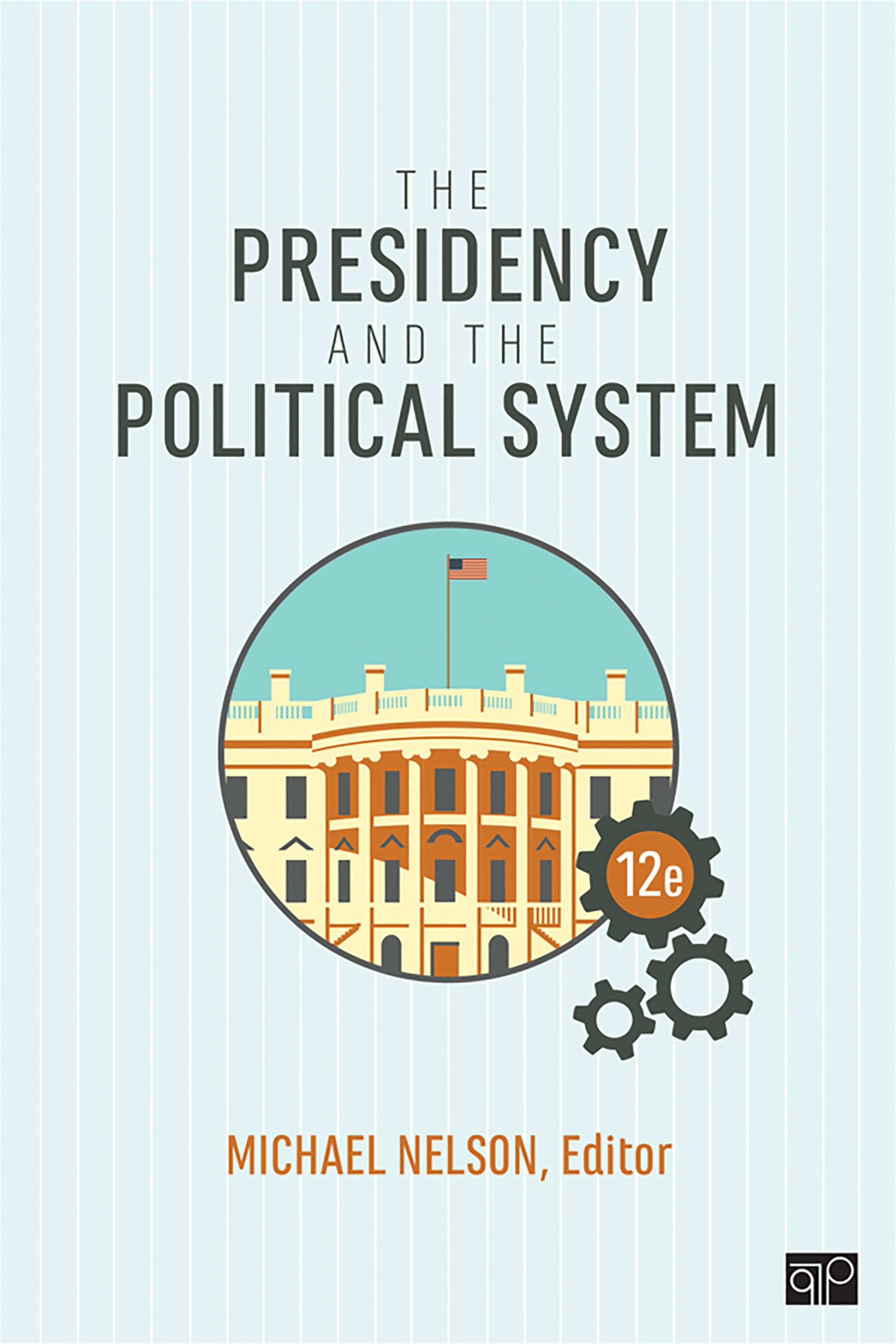
The Presidency and the Political System The Presidency and the Political System showcases the best of presidential studies and research with top-notch presidency scholars writing specifically for an undergraduate audience. Michael Nelson rigorously edits each contribution to present a set of analytical yet accessible chapters and offers contextual headnotes introducing each essay. Chapters represent the full range of topics, institutions, and issues relevant to understanding the American presidency: covering approaches to studying the presidency, elements of presidential power, presidential selection, presidents and politics, and presidents and government. This Twelfth Edition fully incorporates coverage of the Trump administration. POLITICAL SCIENCE,American Government,Executive Branch

The Black Presidency A provocative and lively examination of the meaning of America's first black presidency, by the New York Times-bestselling author of Tears We Cannot Stop. Michael Eric Dyson explores the powerful, surprising way the politics of race have shaped Barack Obama’s identity and groundbreaking presidency. How has President Obama dealt publicly with race—as the national traumas of Tamir Rice, Trayvon Martin, Michael Brown, Eric Garner, Freddie Gray, and Walter Scott have played out during his tenure? What can we learn from Obama's major race speeches about his approach to racial conflict and the black criticism it provokes? Dyson explores whether Obama’s use of his own biracialism as a radiant symbol has been driven by the president’s desire to avoid a painful moral reckoning on race. And he sheds light on identity issues within the black power structure, telling the fascinating story of how Obama has spurned traditional black power brokers, significantly reducing their leverage. President Obama’s own voice—from an Oval Office interview granted to Dyson for this book—along with those of Eric Holder, Al Sharpton, Jesse Jackson, Andrew Young, and Maxine Waters, among others, add unique depth to this profound tour of the nation’s first black presidency. “Dyson proves…that he is without peer when it comes to contextualizing race in twenty-first-century America… A must-read for anyone who wants to better understand America’s racial past, present, and future.â€â€”Gilbert King, author of the Pulitzer Prize–winning Devil in the Grove “No one understands the American dilemma of race—and Barack Obama’s confounding and yet wondrous grappling with it—better than [Dyson.]â€â€”Douglas Blackmon, author of the Pulitzer Prize–winning Slavery by Another Name POLITICAL SCIENCE,American Government,Executive Branch
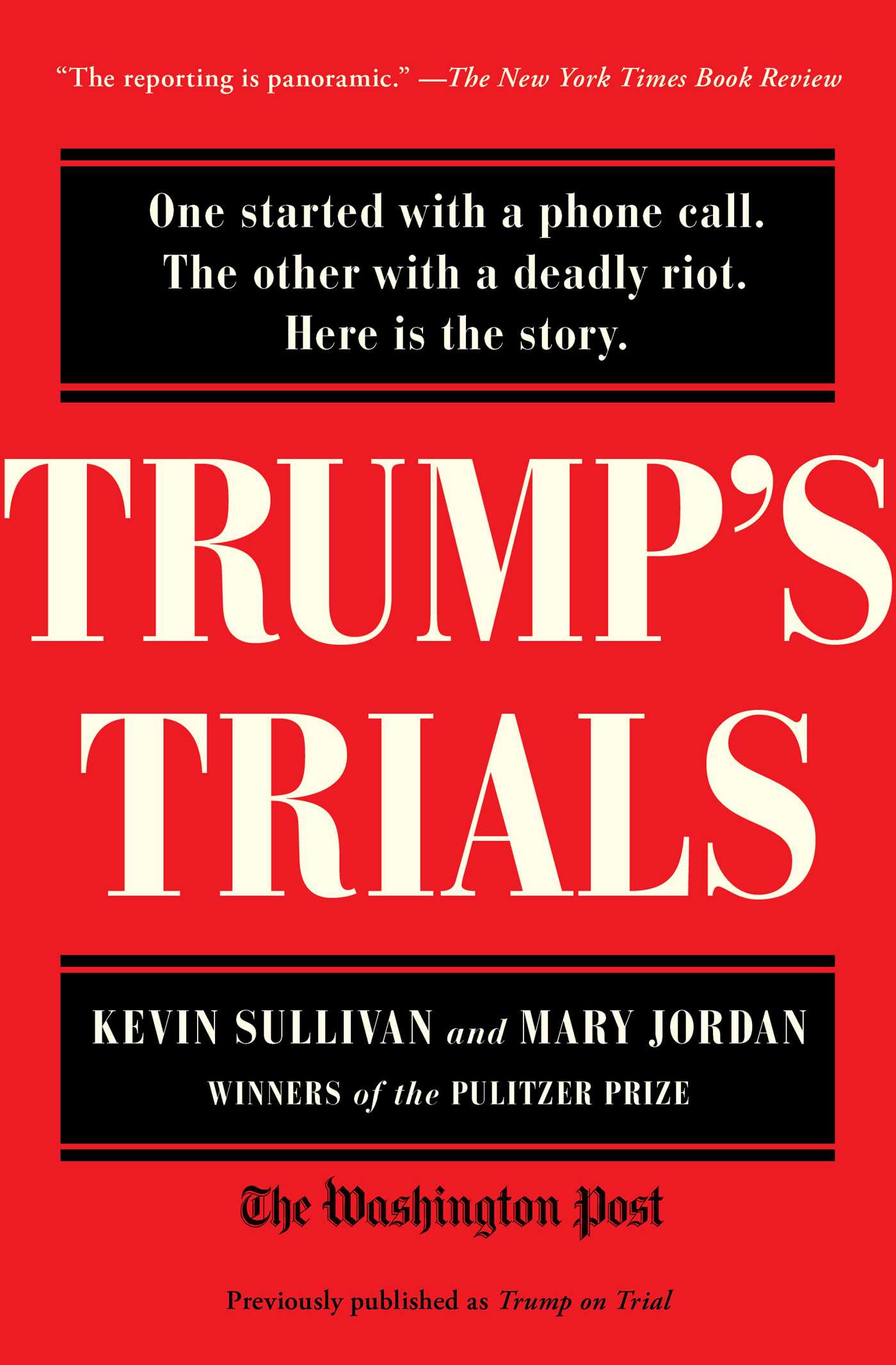
Trump on Trial A compelling and masterful account, based on fresh reporting, of the investigation, impeachment, and acquittal of President Donald Trump, a ferocious political drama that challenged American democracy itself. In the spring of 2019, Speaker of the House Nancy Pelosi did not favor pursuing Trump’s impeachment. Her view was: “He’s just not worth it.†But by September, after a whistleblower complaint suggesting that Trump had used his office for his political benefit, Pelosi decided to risk it. The impeachment inquiry led to charges of abuse of power and obstruction of Congress, a gamble that ultimately meant Trump would be the first impeached president on the ballot in US history. Pulitzer Prize–winning Washington Post reporters Kevin Sullivan and Mary Jordan have crafted a powerful, intimate narrative that concentrates on the characters as well as the dramatic events, braiding them together to provide a remarkable understanding of what happened and why. Drawing on the deep reporting of Post journalists as well as new interviews, Sullivan and Jordan deliver a crisp page-turner with exquisite detail and scenes. They put readers in the room for both sides of the now-famous phone call between Trump and Ukrainian president Volodymyr Zelensky on July 25, 2019, revealing the in-the-moment reactions of those listening to the call in Washington, as well as the tension in Kyiv, as aides passed notes to Zelensky while he was talking to Trump. Sullivan and Jordan deftly illuminate the aims and calculations of key figures. Pelosi’s evolution from no to yes. Trump’s mounting fury as “the I-word†became inevitable. Senate majority leader Mitch McConnell firmly telling Trump on the phone about the Senate trial: You need to trust me. Trump on Trial teems with unexpected moments. House member Elissa Slotkin, a Michigan Democrat, alone at the National Archives, walking amid the nation’s founding documents, weighing her vote on impeachment. Fiery Republican congressman Matt Gaetz of Florida, a favorite Trump warrior, deciding to lead the storming of the secure room in the US Capitol basement, where witnesses were testifying. The authors paint vivid portraits of the men and women branded by the president’s supporters as foes from the “deep stateâ€: Ukraine experts Fiona Hill and Lt. Col. Alexander Vindman; ambassadors Marie Yovanovitch and William Taylor. The narrative spools out amid Trump’s nonstop tweeting and the infinite echo chamber of social media, which amplified both parties’ messages in ways unknown during past impeachments. Sullivan and Jordan, aided by editor Steve Luxenberg, follow the story into the aftermath of Trump’s acquittal and the president’s payback for those whom he believed had betrayed him. The retributions took place as the nation reeled from a devastating pandemic and widespread protests about racial injustice, with another trial looming: the 2020 election. POLITICAL SCIENCE,American Government,Executive Branch
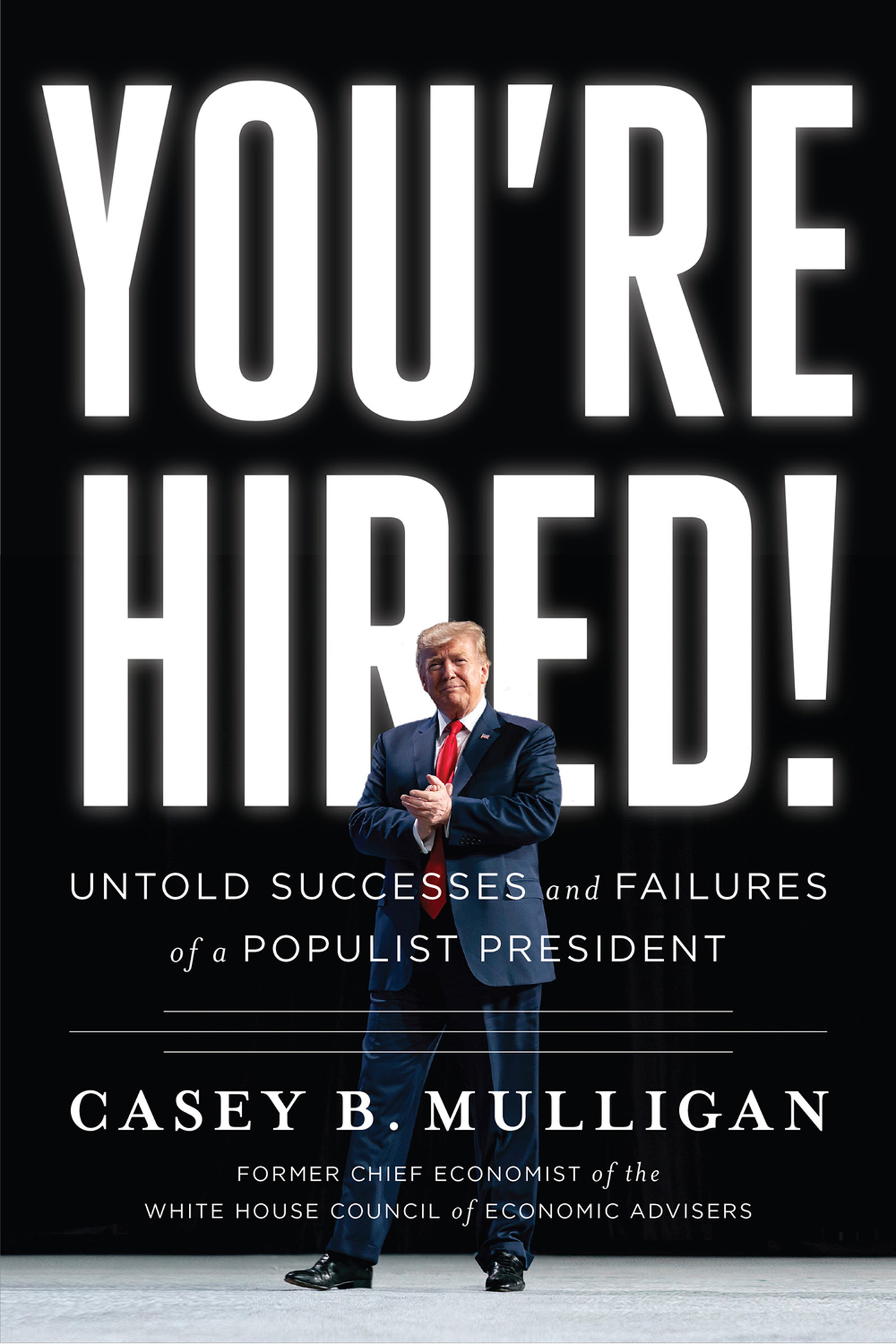
You're Hired! Donald J. Trump had essentially zero experience running for office and his candidacy for President of the United States was opposed by many in both parties that dominate American politics. Nevertheless, in 2016 the American people told him “You're hired!”. As an insider, scholar, and Chief Economist of the President's Council of Economic Advisers, Casey Mulligan presents riveting first-hand accounts of President Trump's engagement with policy and politics. The struggle between Trump and a ruling class is skillfully presented by revealing business practices that President Trump is using to dismantle and reshape the Federal administrative state. It proves that today's populism has some real substance, but also acknowledges Trump's political incorrectness. You're Hired! brilliantly details the administration's successes and failures alongside the scandals, and accurately portrays the approach and capabilities of our President and our government. You will feel like an insider as you learn how Trump handles auto companies, Senator Bernie Sanders, immigration, international aid, the 2016 election, Twitter, and more that the news media has often failed to report or explain. Rigorous evidence is detailed on assertions that the White House staff is in perpetual chaos which is directly attributable to the President. A fascinating comparison of the similarities and differences between Presidents Reagan and Trump is presented along with topics including Obamacare, Putin, the opioid epidemic, and tariffs. This book highlights the great divides created by the President and his “Make America Great Again” (MAGA) supporters being on one side and a small, unelected, and insulated class who have years of experience running, and reporting on the Federal government being on the other side. Anyone wanting to understand, emulate, or oppose President Trump's “populist” methods will be enthralled by accurate first-hand accounts of how he engages with policy and politics. POLITICAL SCIENCE,American Government,Executive Branch
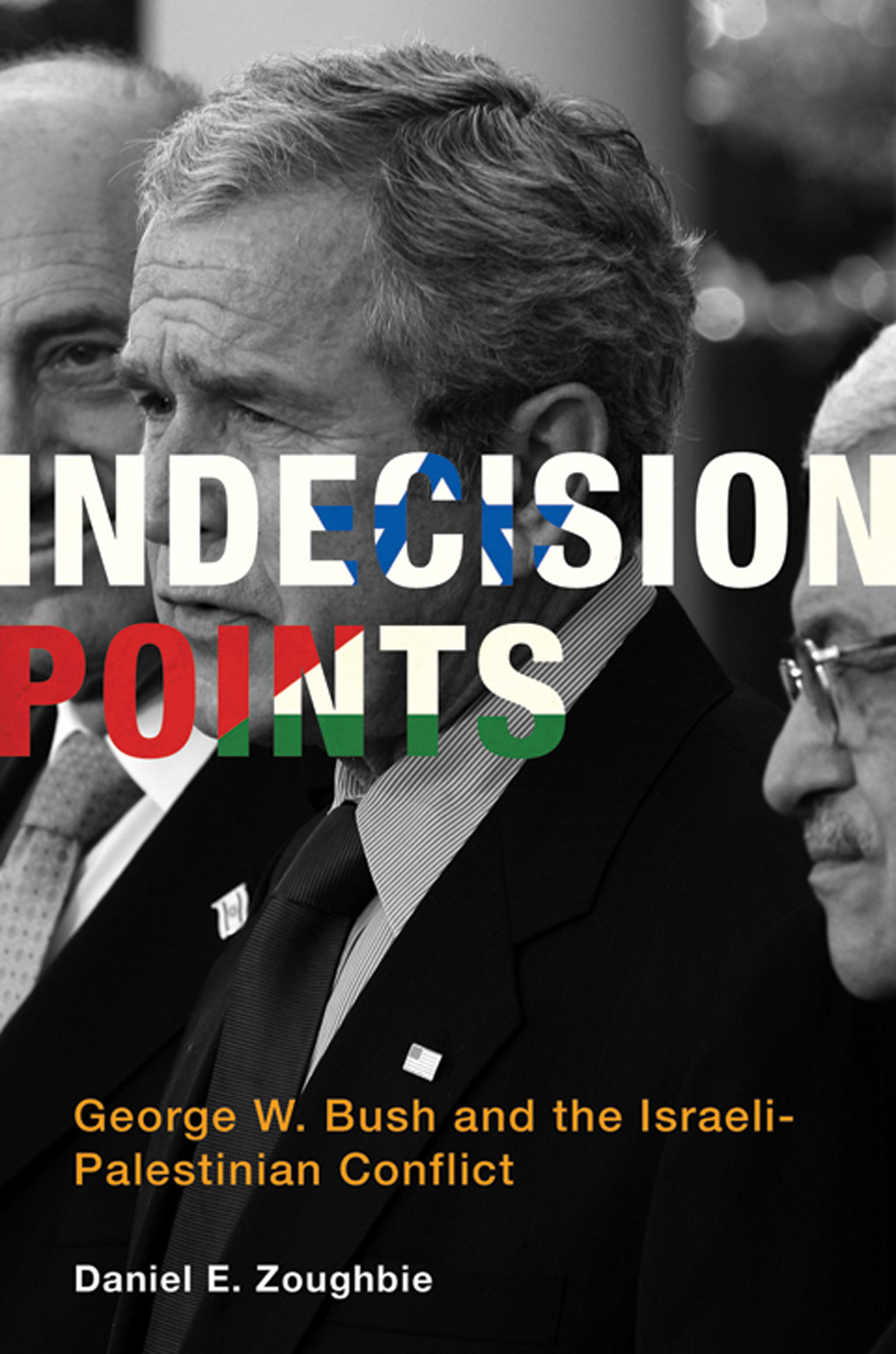
Indecision Points How a president who prided himself on his decisiveness vacillated between policy approaches in the Middle East. Although George W. Bush memorably declared, “I'm the decider,” as president he was remarkably indecisive when it came to U.S. policy toward the Israeli-Palestinian conflict. His administration's policymaking featured an ongoing clash between moderate realists and conservative hard-liners inspired by right-wing religious ideas and a vision of democracy as cure-all. Riven by these competing agendas, the Bush administration vacillated between recognizing the Palestinian right to self-determination and embracing Israeli leaders who often chose war over negotiations. Through the years, the administration erratically adopted and discarded successive approaches to the Israeli-Palestinian peace process. The results of this irresolution included the stunning triumph of Hamas in the 2006 Palestinian elections, Israel's 2006 invasion of Lebanon, the 2008–2009 clash between Israel and Hamas in Gaza, and, in the end, virtually no diplomatic progress toward lasting peace. In Indecision Points, Daniel Zoughbie examines the major assumptions underpinning U.S. foreign policy in the Middle East during the Bush years. Was there one policy or two? Was the Bush administration truly serious about peace? In a compelling account, Zoughbie offers original insights into these and other important questions. Drawing on the auhtor's own interviews with forty-five global leaders, including Condoleezza Rice, former Archbishop of Canterbury Rowan Williams, Kofi Annan, Colin Powell, Tom DeLay, Paul Wolfowitz, Douglas Feith, Richard Perle, Leon Panetta, Chuck Hagel, Shlomo Ben Ami, and Salam Fayyad, Indecision Points provides the first comprehensive history of the Bush administration's attempt to reshape political order in a “New Middle East.” POLITICAL SCIENCE,American Government,Executive Branch

The Truth of Power Ideas and the presidency flirt with each other, but can they really get along? President Clinton had a romance with big ideas. He intently cultivated intellectuals, seducing them with his characteristic charm and with the promise of real influence on the political stage. Yet most often he disappointed the big thinkers whose advice he sought. Benjamin Barber was first invited to Camp David in 1994, along with other prominent members of the academic community, to participate in a "seminar" with President Clinton on the future of Democratic ideas and ideals. Afterwards, he became a steady informal adviser to the White House. For a politically committed professor like Barber, the opportunity was exhilarating—here was an opportunity to put ideas into action, to link ideas to power. The result was enlightening, if unexpected. The most unpredictable factor was the president himself: a man of astonishing intellectual gifts, a consummate listener and synthesizer of ideas, who nonetheless failed to present a stirring progressive vision or even to craft a memorable speech. With great perceptiveness, wit, and élan, Barber provides a startling meditation on truth and power—and the truth of power, which is the responsibility of the elected not to an idea but to the electorate. He identifies the fault lines that future progressive candidates must straddle if they are to win—and the gift they must have, if they are to be great, of calling forth the best in their fellow citizens. In the end, Barber give us a unique portrait of our compelling and maddening ex-president, and the hopes and disillusionments he represents. POLITICAL SCIENCE,American Government,Executive Branch
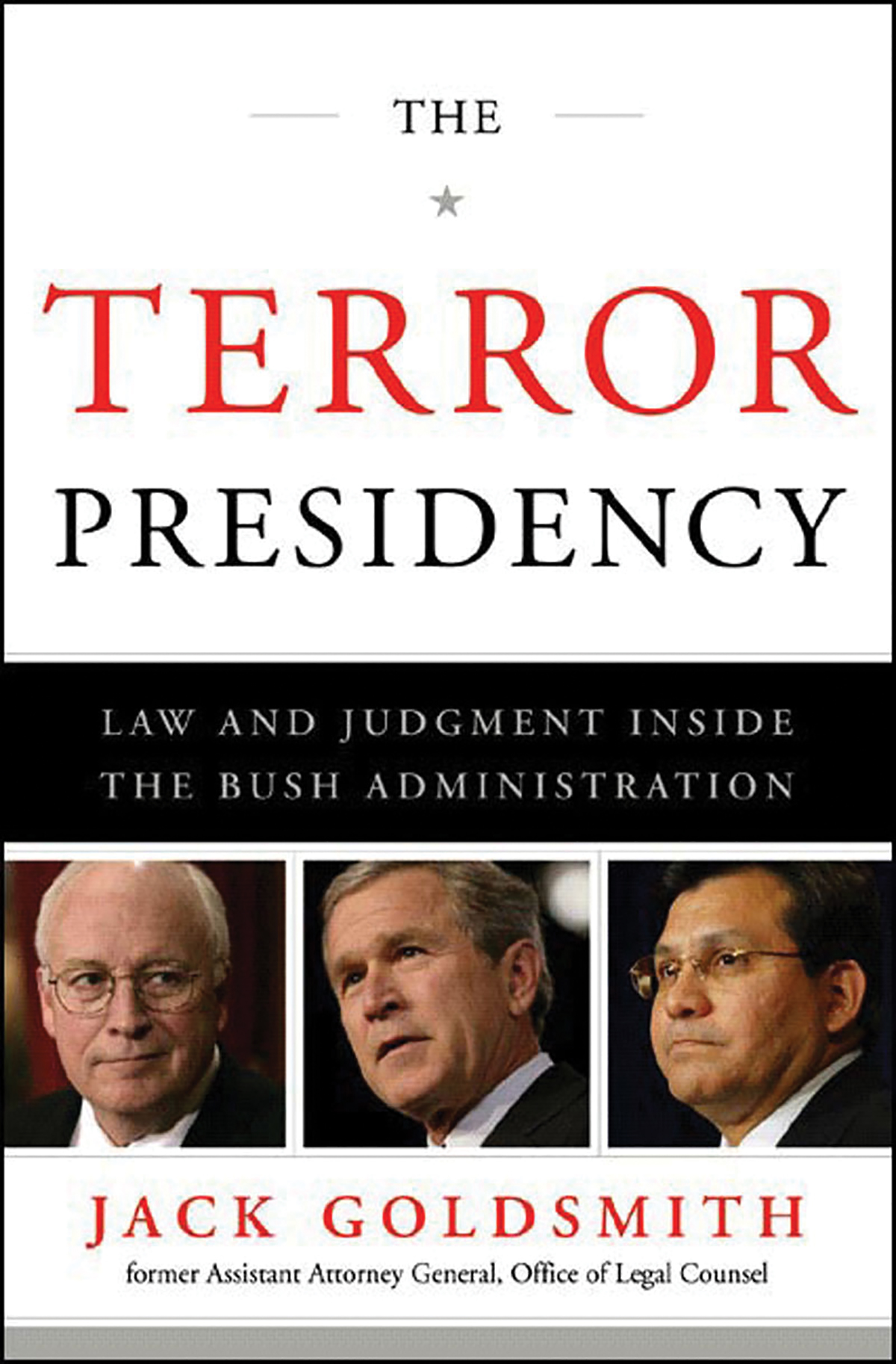
The Terror Presidency A central player's account of the clash between the rule of law and the necessity of defending America. Jack Goldsmith's duty as head of the Office of Legal Counsel was to advise President Bush what he could and could not do...legally. Goldsmith took the job in October 2003 and began to review the work of his predecessors. Their opinions were the legal framework governing the conduct of the military and intelligence agencies in the war on terror, and he found many—especially those regulating the treatment and interrogation of prisoners—that were deeply flawed. Goldsmith is a conservative lawyer who understands the imperative of averting another 9/11. But his unflinching insistence that we abide by the law put him on a collision course with powerful figures in the administration. Goldsmith's fascinating analysis of parallel legal crises in the Lincoln and Roosevelt administrations shows why Bush's apparent indifference to human rights has damaged his presidency and, perhaps, his standing in history. POLITICAL SCIENCE,American Government,Executive Branch
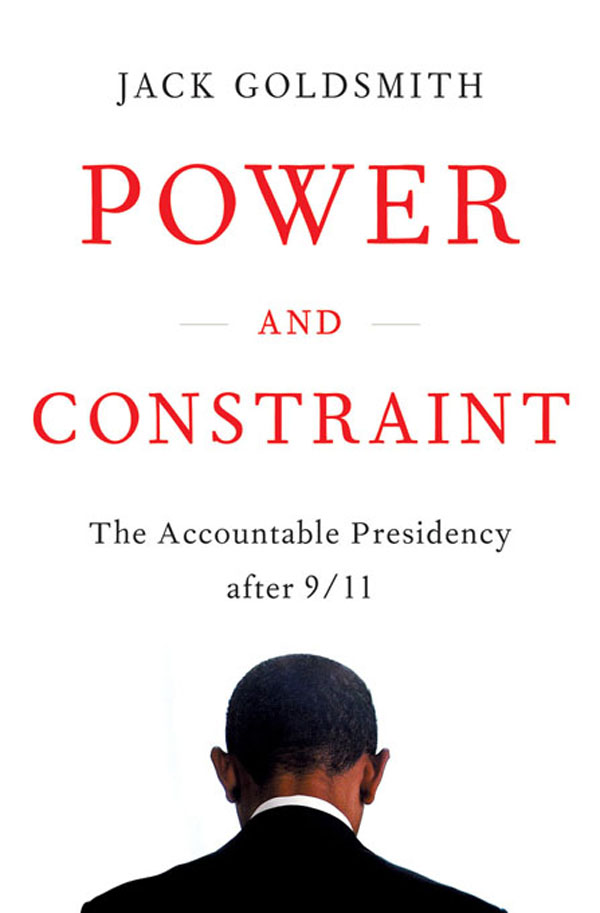
Power and Constraint The surprising truth behind Barack Obama's decision to continue many of his predecessor's counterterrorism policies. Conventional wisdom holds that 9/11 sounded the death knell for presidential accountability. In fact, the opposite is true. The novel powers that our post-9/11 commanders in chief assumed—endless detentions, military commissions, state secrets, broad surveillance, and more—are the culmination of a two-century expansion of presidential authority. But these new powers have been met with thousands of barely visible legal and political constraints—enforced by congressional committees, government lawyers, courts, and the media—that have transformed our unprecedentedly powerful presidency into one that is also unprecedentedly accountable. These constraints are the key to understanding why Obama continued the Bush counterterrorism program, and in this light, the events of the last decade should be seen as a victory, not a failure, of American constitutional government. We have actually preserved the framers’ original idea of a balanced constitution, despite the vast increase in presidential power made necessary by this age of permanent emergency. POLITICAL SCIENCE,American Government,Executive Branch
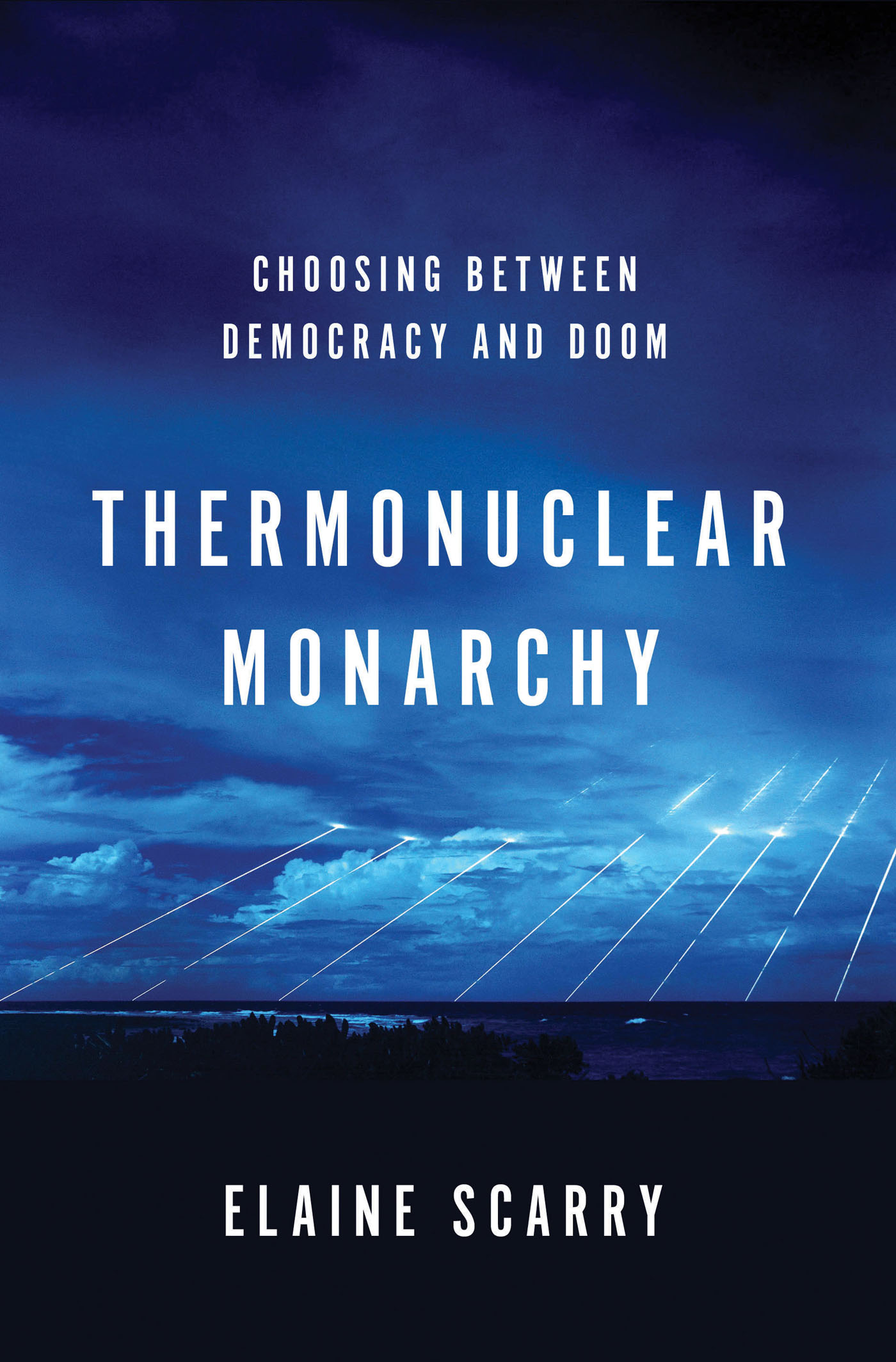
Thermonuclear Monarchy From one of our leading social thinkers, a compelling case for the elimination of nuclear weapons. During his impeachment proceedings, Richard Nixon boasted, "I can go into my office and pick up the telephone and in twenty-five minutes seventy million people will be dead." Nixon was accurately describing not only his own power but also the power of every American president in the nuclear age.Presidents Eisenhower, Kennedy, Johnson, and Nixon each contemplated using nuclear weapons—Eisenhower twice, Kennedy three times, Johnson once, Nixon four times. Whether later presidents, from Ford to Obama, considered using them we will learn only once their national security papers are released. In this incisive, masterfully argued new book, award-winning social theorist Elaine Scarry demonstrates that the power of one leader to obliterate millions of people with a nuclear weapon—a possibility that remains very real even in the wake of the Cold War—deeply violates our constitutional rights, undermines the social contract, and is fundamentally at odds with the deliberative principles of democracy. According to the Constitution, the decision to go to war requires rigorous testing by both Congress and the citizenry; when a leader can single-handedly decide to deploy a nuclear weapon, we live in a state of “thermonuclear monarchy,†not democracy. The danger of nuclear weapons comes from potential accidents or acquisition by terrorists, hackers, or rogue countries. But the gravest danger comes from the mistaken idea that there exists some case compatible with legitimate governance. There can be no such case. Thermonuclear Monarchy shows the deformation of governance that occurs when a country gains nuclear weapons. In bold and lucid prose, Thermonuclear Monarchy identifies the tools that will enable us to eliminate nuclear weapons and bring the decision for war back into the hands of Congress and the people. Only by doing so can we secure the safety of home populations, foreign populations, and the earth itself. POLITICAL SCIENCE,American Government,Executive Branch

War and the American Presidency "Historical reflections that deftly challenge the political and ideological foundations of President Bush's foreign policy."--Charles A. Kupchan, New York Times In a book that brings a magisterial command of history to the most urgent of contemporary questions, two-time Pulitzer Prize-winning historian Arthur M. Schlesinger, Jr., explores the war in Iraq, the presidency, and the future of democracy. Describing unilateralism as "the oldest doctrine in American history," Schlesinger nevertheless warns of the dangers posed by the fatal turn in U.S. policy from deterrence and containment to preventive war. He writes powerfully about George W. Bush's expansion of presidential power, reminding us nevertheless of our country's distinguished legacy of patriotism through dissent in wartime. And in a new chapter written especially for the paperback edition, he examines the historical role of religion in American politics as a background for an assessment of Bush's faith-based presidency. POLITICAL SCIENCE,American Government,Executive Branch
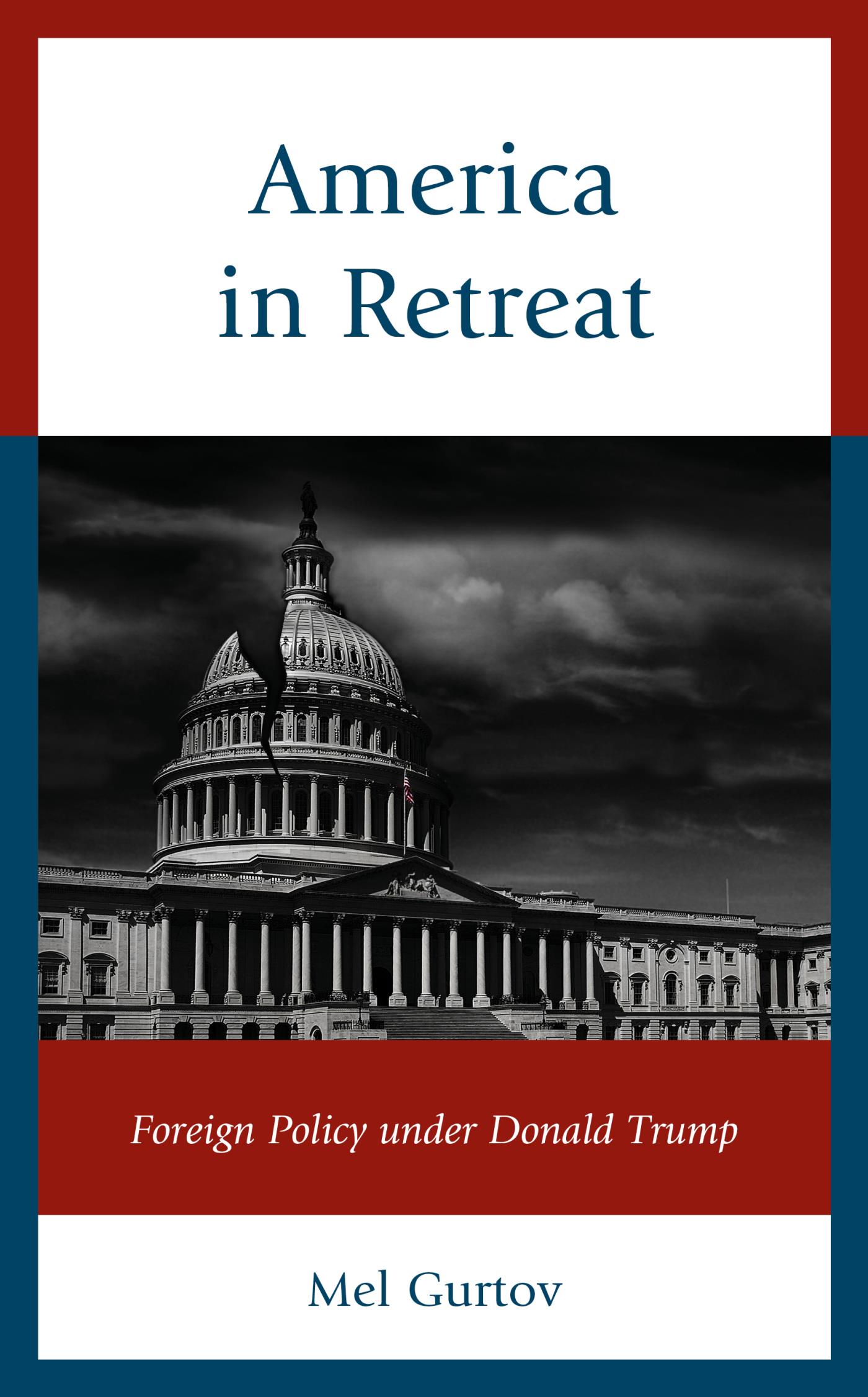
America in Retreat This book provides a comprehensive analysis of Trump’s foreign policy, including detailed case studies of policy toward key countries. Mel Gurtov makes a vigorous argument, centered on human-interest priorities, for rejecting a foreign policy that turns its back on the major issues of our times. POLITICAL SCIENCE,American Government,Executive Branch

Executive Secrets A frank and refreshing evaluation of several Chief Executives, their Directors of Central Intelligence, and even some lower in the hierarchy, Executive Secrets shines light on the development and execution of foreign policy through the understanding of the tools available, of which covert action may be least known and understood. This book is a great tool for the press, the public, and many political appointees in the National Security System. A History Book Club Selection with a foreword by Mark Bowden, author of Black Hawk Down. POLITICAL SCIENCE,American Government,Executive Branch
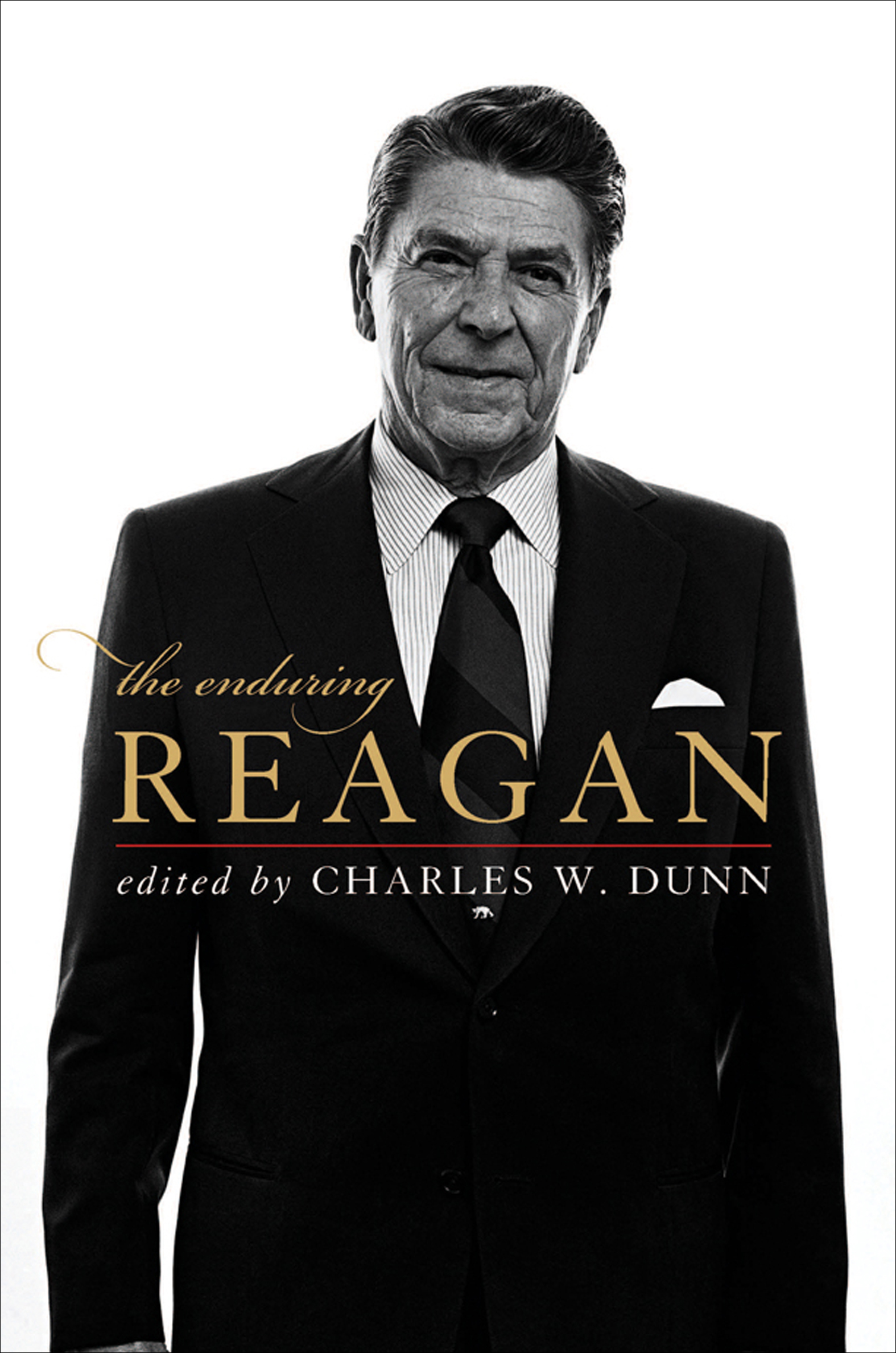
The Enduring Reagan A former Sunday school teacher and Hollywood actor, Ronald Reagan was an unlikely candidate for president. His charisma, conviction, and leadership earned him the governorship of California, from which he launched his successful bid to become the fortieth president of the United States in 1980. Reagan's political legacy continues to be the standard by which all conservatives are judged. In The Enduring Reagan, editor Charles W. Dunn brings together eight prominent scholars to examine the political career and legacy of Ronald Reagan. This anthology offers a bold reassessment of the Reagan years and the impact they had on the United States and the world. POLITICAL SCIENCE,American Government,Executive Branch
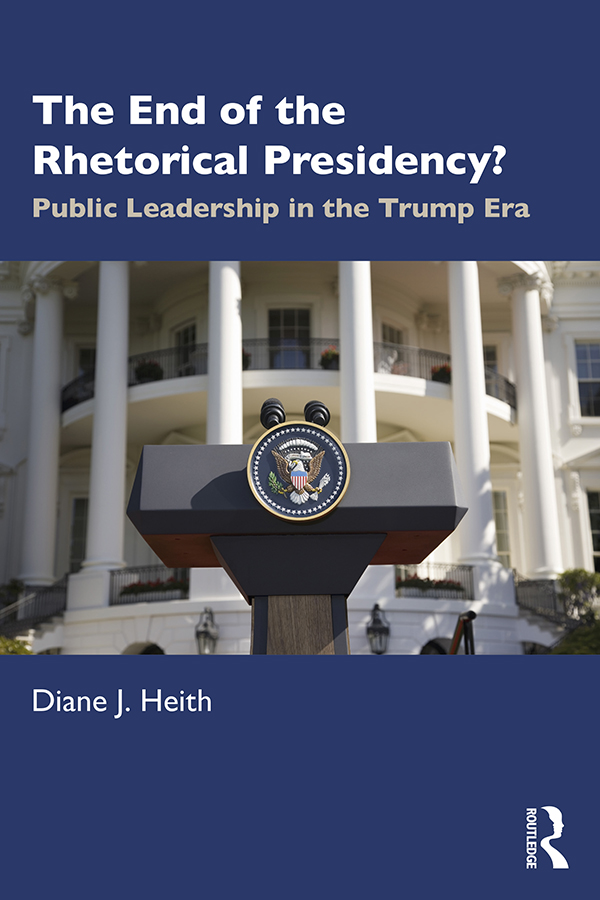
The End of the Rhetorical Presidency? The End of the Rhetorical Presidency? Public Leadership in the Trump Era explores one of the most disruptive aspects of the Trump presidency. Since the FDR administration, presidents developed the capacity and skill to use the public to influence the legislative arena, gain reelection, survive scandal and secure their legacy. Consequently, presidential rhetorical leadership has its own norms and expectations. Comparing President Trump’s communications apparatus as well as rhetoric (including Twitter) to previous presidents, Diane Heith demonstrates how Trump exercises leadership by adhering to some of these norms and expectations, but rejects, abandons and undermines most. Heith argues that his individual, rather than institutional, approach to leadership represents a change in tone, language and style. She concludes that the loss of skill and capacity represents a devolution of the White House institution dedicated to public leadership, especially in the legislative arena. More significantly, the individual approach emphasizes weakening the ability of the press and other political elites to hold the president accountable. This book will appeal to students and scholars of the presidency as well as general readers who quest for a deeper understanding of the Trump White House. POLITICAL SCIENCE,American Government,Executive Branch

Where Law Ends NEW YORK TIMES BESTSELLER • In the first and only inside account of the Mueller investigation, one of the special counsel’s most trusted prosecutors breaks his silence on the team’s history-making search for the truth, their painstaking deliberations and costly mistakes, and Trump’s unprecedented efforts to stifle their report. “Weissmann delivers the kind of forceful, ringing indictment that Mueller’s report did not.”—The New York Times In May 2017, Robert Mueller was tapped to lead an inquiry into Russian interference in the 2016 presidential election, coordination by foreign agents with Donald Trump’s campaign, and obstruction of justice by the president. Mueller assembled a “dream team” of top prosecutors, and for the next twenty-two months, the investigation was a black box and the subject of endless anticipation and speculation—until April 2019, when the special counsel’s report was released. In Where Law Ends, legendary prosecutor Andrew Weissmann—a key player in the Special Counsel’s Office—finally pulls back the curtain to reveal exactly what went on inside the investigation, including the heated debates, painful deliberations, and mistakes of the team—not to mention the external efforts by the president and Attorney General William Barr to manipulate the investigation to their political ends. Weissmann puts the reader in the room as Mueller’s team made their most consequential decisions, such as whether to subpoena the president, whether to conduct a full financial investigation of Trump, and whether to explicitly recommend obstruction charges against him. Weissmann also details for the first time the debilitating effects that President Trump himself had on the investigation, through his dangling of pardons and his constant threats to shut down the inquiry and fire Mueller, which left the team racing against the clock and essentially fighting with one hand tied behind their backs. In Where Law Ends, Weissmann conjures the camaraderie and esprit de corps of the investigative units led by the enigmatic Mueller, a distinguished public servant who is revealed here, in a way we have never seen him before, as a manager, a colleague, and a very human presence. Weissmann is as candid about the team’s mistakes as he is about its successes, and is committed to accurately documenting the historic investigation for future generations to assess and learn from. Ultimately, Where Law Ends is a story about a team of public servants, dedicated to the rule of law, tasked with investigating a president who did everything he could to stand in their way. POLITICAL SCIENCE,American Government,Executive Branch
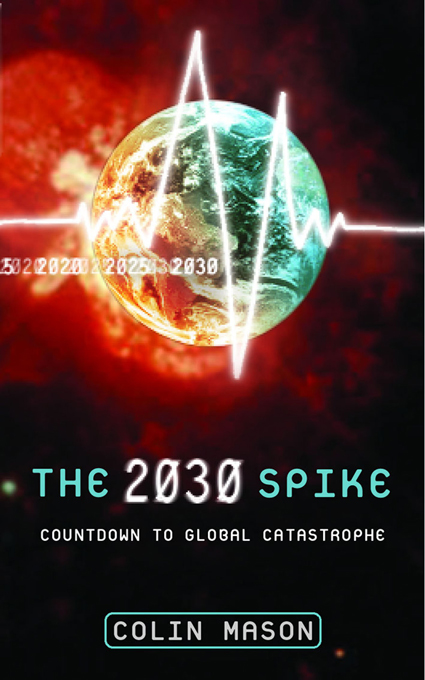
The 2030 Spike The clock is relentlessly ticking!Our world teeters on a knife-edge between a peaceful and prosperous future for all, and a dark winter of death and destruction that threatens to smother the light of civilization. Within 30 years, in the 2030 decade, six powerful 'drivers' will converge with unprecedented force in a statistical spike that could tear humanity apart and plunge the world into a new Dark Age. Depleted fuel supplies, massive population growth, poverty, global climate change, famine, growing water shortages and international lawlessness are on a crash course with potentially catastrophic consequences. In the face of both doomsaying and denial over the state of our world, Colin Mason cuts through the rhetoric and reams of conflicting data to muster the evidence to illustrate a broad picture of the world as it is, and our possible futures. Ultimately his message is clear; we must act decisively, collectively and immediately to alter the trajectory of humanity away from catastrophe.Offering over 100 priorities for immediate action, The 2030 Spike serves as a guidebook for humanity through the treacherous minefields and wastelands ahead to a bright, peaceful and prosperous future in which all humans have the opportunity to thrive and build a better civilization.This book is powerful and essential reading for all people concerned with the future of humanity and planet earth. POLITICAL SCIENCE,American Government,General

Washington Rules The bestselling author of The Limits of Power critically examines the Washington consensus on national security and why it must change. POLITICAL SCIENCE,American Government,General

Letter to a New President A legendary Senator advises our next President on the commonsense values necessary to lead our nation United States Senator Robert C. Byrd is the longest-serving member of the United States Senate in the history of our great Republic. Senator Byrd has served the people of West Virginia, and the nation, for fifty-four years, and has served alongside eleven Presidents. He was twice elected by his colleagues to the position of Senate Majority Leader and currently is chairman of the powerful Senate Appropriations Committee. Byrd has lived through two world wars, the Great Depression, the civil rights movement, the Cold War, the resignation of a U.S. President, the 9/11 terrorist attacks, and traumatic military conflicts around the globe, including Iraq and Vietnam. Byrd has been a witness to it all. And now, in his ninetieth year of life, he wants to share the commonsense lessons he has learned from his unique vantage point in history.In Letter to a New President, Byrd recounts lessons drawn from his remarkable life as a young boy growing up poor in the coalfields of southern West Virginia to his meteoric rise to the pinnacles of power in Washington, D.C. From his unique vantage point in history, Byrd focuses his observations on underappreciated and seldom discussed virtues like personal responsibility, careful consideration before making decisions, and a sense of decency and fairness even toward fierce opponents. A student of history and a defender of our Constitution, Byrd looks to the past for lessons and, in Letter to a New President, studies present failures as guides for constructive lessons for the future.This book will help the next President grapple with the heavy demands of the office. Every American who cares about where this country is heading will find rich wisdom in Byrd's sage advice.Enlightened by a wide-ranging knowledge of American history and a love for the guiding principles of the Constitution, Byrd's observations sharpen the focus of the historical moment in which we find ourselves, as no one but Senator Byrd can. POLITICAL SCIENCE,American Government,General
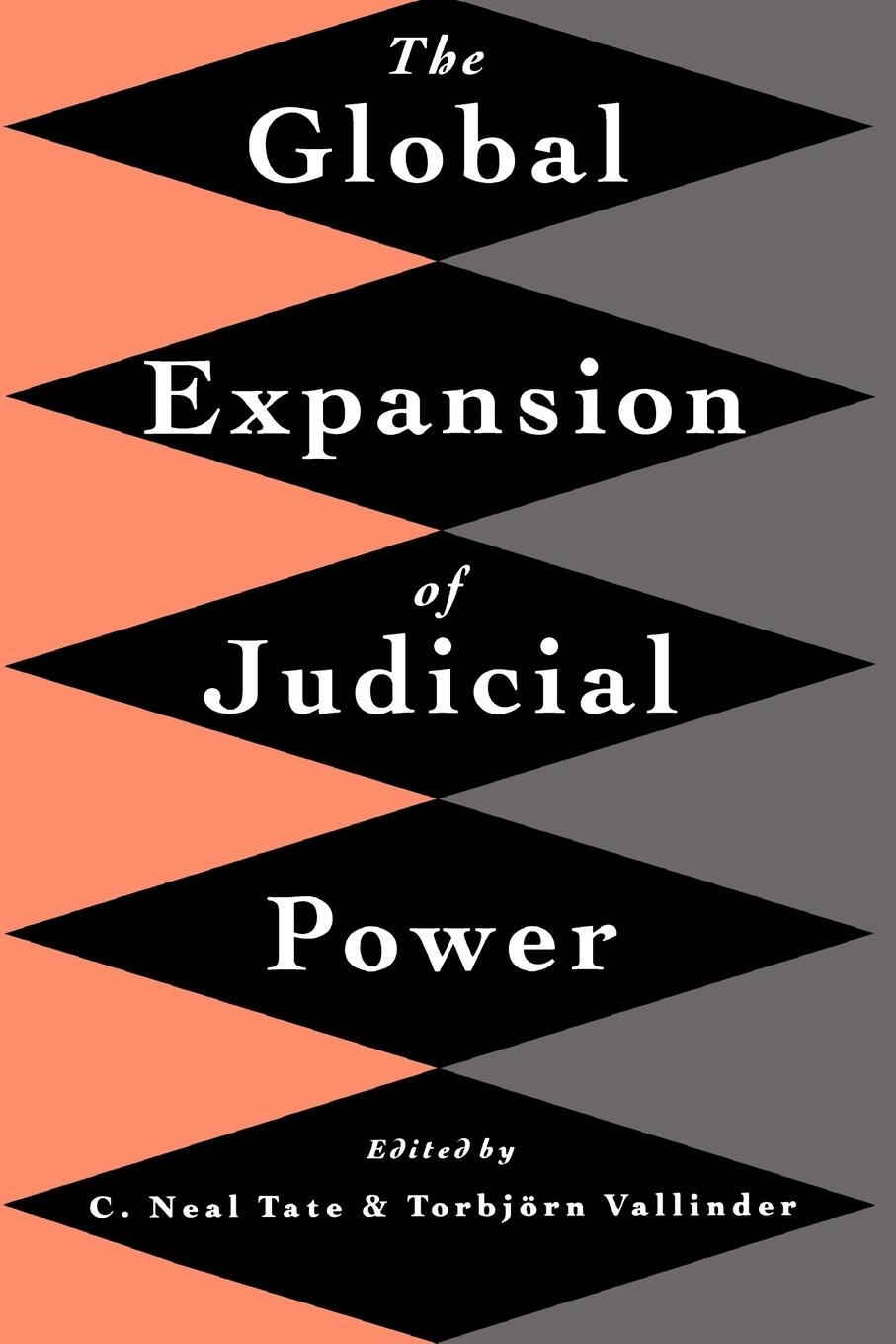
The Global Expansion of Judicial Power In Russia, as the confrontation over the constitutional distribution of authority raged, Boris Yeltsin's economic program regularly wended its way in and out of the Constitutional Court until Yeltsin finally suspended that court in the aftermath of his clash with the hard-line parliament. In Europe, French and German legislators and executives now routinely alter desired policies in response to or in anticipation of the pronouncements of constitutional courts. In Latin America and Africa, courts are--or will be-- important participants in ongoing efforts to establish constitutional rules and policies protect new or fragile democracies from the threats of military intervention, ethnic conflict, and revolution. This global expansion of judicial power, or judicialization of politics is accompanied by an increasing domination of negotiating or decision making arenas by quasi- judicial procedures. For better or for worse, the judicialization of politics has become one of the most significant trends of the end of the millenium.In this book, political scientists, legal scholars, and judges around the world trace the intellectual origins of this trend, describe its occurence--or lack of occurence--in specific nations, analyze the circumstances and conditions that promote or retard judicialization, and evaluate the phenomenon from a variety of intellectual and ideological perspectives. POLITICAL SCIENCE,American Government,General

Elites and Governance in China This book reveals the complex relationship between elite perceptions and behaviour, and governance, in China. It moves away from existing scholarship by focusing on functionaries, grass-roots elites, leading intellectuals, and opinion-makers in China and by looking beyond the top leadership, makes a significant contribution to our understanding of shared governance and broadened political participation in China. The chapters in this collection explore the elites’ role as opinion-makers, technical experts, producers of knowledge, and executives or managers, and pose a number of questions, the answers to which are crucial to understanding future political and economic development in China. What are elite perceptions of governance, inequality and justice; what do the elites mean by good governance; what is the influence of non-Chinese Communist Party elites in policy-making and implementation in China; how have they exerted their influence in the PRC and influenced its direction of future development; and what have grass-roots elites contributed to governance in local communities? Providing a keen insight into the role elites have played in governing China since 1978, this book is a pioneering effort to bring together elite studies and governance studies. As such, it will be highly relevant for policy-makers within international organizations, governments, and NGOs outside China as well as appealing to scholars and students interested in Chinese politics and governance. POLITICAL SCIENCE,American Government,General
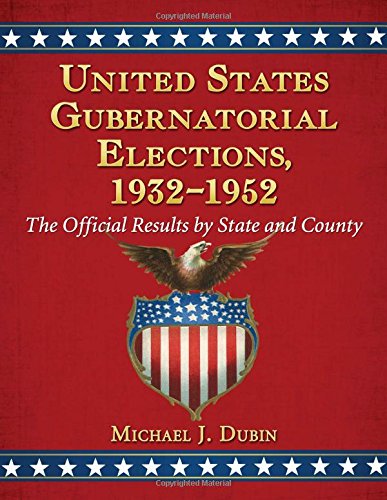
United States Gubernatorial Elections, 1932-1952 This book is the definitive record of election results in all states' gubernatorial races from 1932 to 1952 for every candidate who received at least one percent of the total vote. It offers the reader both state and county level voting details of the highest directly elected office in the nation. Virtually all candidates are identified by party affiliation. The returns are presented in two parts. The first section provides an annual summary of gubernatorial votes by year, organized alphabetically by state. The second section provides returns by county for all candidates receiving at least one percent of the state vote. State totals are given for all candidates. Data are based on official election returns. POLITICAL SCIENCE,American Government,General

Athens, Rome, and England Uncovering the roots of the U.S. Constitution POLITICAL SCIENCE,American Government,General

Democracy In America Over the course of nine months in 1831 Alexis de Tocqueville, a French political thinker, accompanied by Gustave de Beaumont, travelled the United States under the pretext of studying the American prison system. Over the course of his travels, Tocqueville also studied American society, religion, politics, and economics, undertaking what would become one of the most comprehensive studies to that time of the practice of democracy in the United States. First published in 1835, Democracy in America continues to be considered one of the foundational works of political science. Democracy in America: Volumes I and II includes both volumes of de Tocqueville’s influential work. Volume I explores the factors that contributed to the success of democracy in the United States, as well as the possible future of democracy in light of the unique religion and socio-economic factors that existed in the United States at that time. Volume II continues Tocqueville’s exploration of the nature of democracy in the United States, including an analysis of American civil society. HarperTorch brings great works of non-fiction and the dramatic arts to life in digital format, upholding the highest standards in ebook production and celebrating reading in all its forms. Look for more titles in the HarperTorch collection to build your digital library. POLITICAL SCIENCE,American Government,General

The Senate Intelligence Committee Report on Torture “The most extensive review of U.S. intelligence-gathering tactics in generations.” —Los Angeles Times Meticulously formatted, this is a highly readable and fully searchable edition of the official summary report of the Senate Intelligence Committee’s investigation of Central Intelligence Agency interrogation and detention programs launched in the wake of the 9/11 attacks. Based on over six million internal CIA documents, the report details secret prisons, prisoner deaths, interrogation practices, and cooperation with other foreign and domestic agencies. It also examines charges that the CIA deceived elected officials and governmental overseers about the extent and legality of its operations. Over five years in the making, and withheld from public view since its declassification in April, 2014, this is the full summary report as finally released by the United States government on December 9th, 2014. POLITICAL SCIENCE,American Government,General
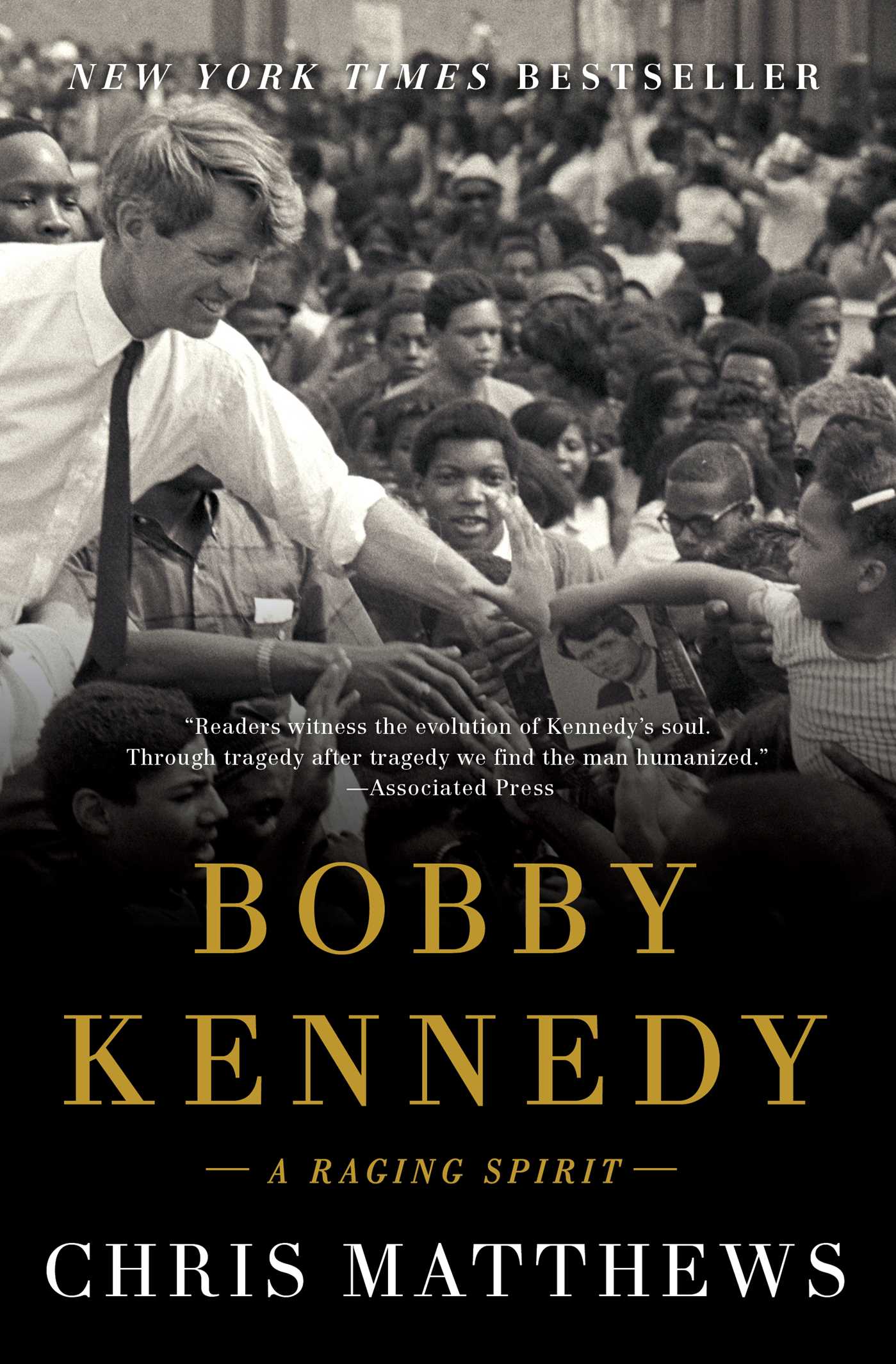
Bobby Kennedy In Chris Matthews’s New York Times bestselling portrait of Robert F. Kennedy, “Readers witness the evolution of Kennedy’s soul. Through tragedy after tragedy we find the man humanized†(Associated Press). With his bestselling biography Jack Kennedy, Chris Matthews profiled of one of America’s most beloved Presidents and the patriotic spirit that defined him. Now, with Bobby Kennedy, Matthews provides “insight into [Bobby’s] spirit and what drove him to greatness†(New York Journal of Books) in his gripping, in-depth, behind-the-scenes look at one of the great figures of the American twentieth century. Overlooked by his father, and overshadowed by his war-hero brother, Bobby Kennedy was a perpetual underdog. When he had the chance to become a naval officer like his older brother, Bobby turned it down, choosing instead to join the Navy as a common sailor. It was a life-changing experience that led him to connect with voters from all walks of life: young and old, black and white, rich and poor. They were the people who turned out for him in his 1968 campaign. RFK would prove himself to be the rarest of politicians—both a pragmatist who knew how to get the job done and an unwavering idealist who could inspire millions. Drawing on extensive research and interviews, Matthews pulls back the curtain on the private world of Robert Francis Kennedy. Matthew illuminates the important moments of his life: from his early years and his start in politics, to his crucial role as attorney general in his brother’s administration and, finally, his tragic run for president. This definitive book brings Bobby Kennedy to life like never before. POLITICAL SCIENCE,American Government,General

American Democracy This book is a comprehensive collection of historic political thought. From the political philosophies of classical and renaissance thinkers to the speeches of American Presidents, it introduces the American Founders’ theories of democracy by connecting and analyzing the words of their philosophical forerunners and Presidential successors. POLITICAL SCIENCE,American Government,General
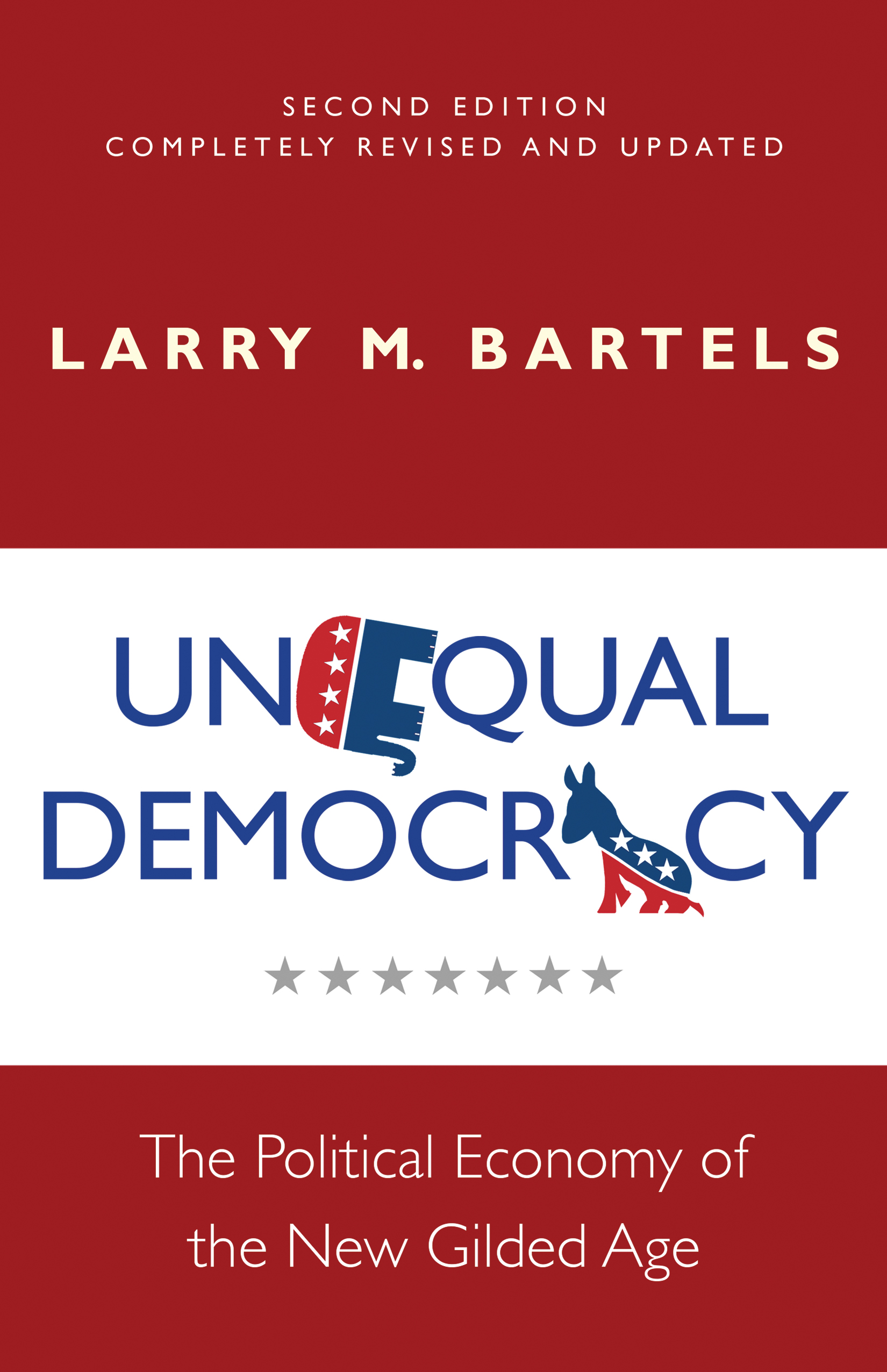
Unequal Democracy An acclaimed examination of how the American political system favors the wealthy—now fully revised and expanded The first edition of Unequal Democracy was an instant classic, shattering illusions about American democracy and spurring scholarly and popular interest in the political causes and consequences of escalating economic inequality. This revised, updated, and expanded second edition includes two new chapters on the political economy of the Obama era. One presents the Great Recession as a "stress test" of the American political system by analyzing the 2008 election and the impact of Barack Obama's "New New Deal" on the economic fortunes of the rich, middle class, and poor. The other assesses the politics of inequality in the wake of the Occupy Wall Street movement, the 2012 election, and the partisan gridlock of Obama’s second term. Larry Bartels offers a sobering account of the barriers to change posed by partisan ideologies and the political power of the wealthy. He also provides new analyses of tax policy, partisan differences in economic performance, the struggle to raise the minimum wage, and inequalities in congressional representation. President Obama identified inequality as "the defining challenge of our time." Unequal Democracy is the definitive account of how and why our political system has failed to rise to that challenge. Now more than ever, this is a book every American needs to read. POLITICAL SCIENCE,American Government,General
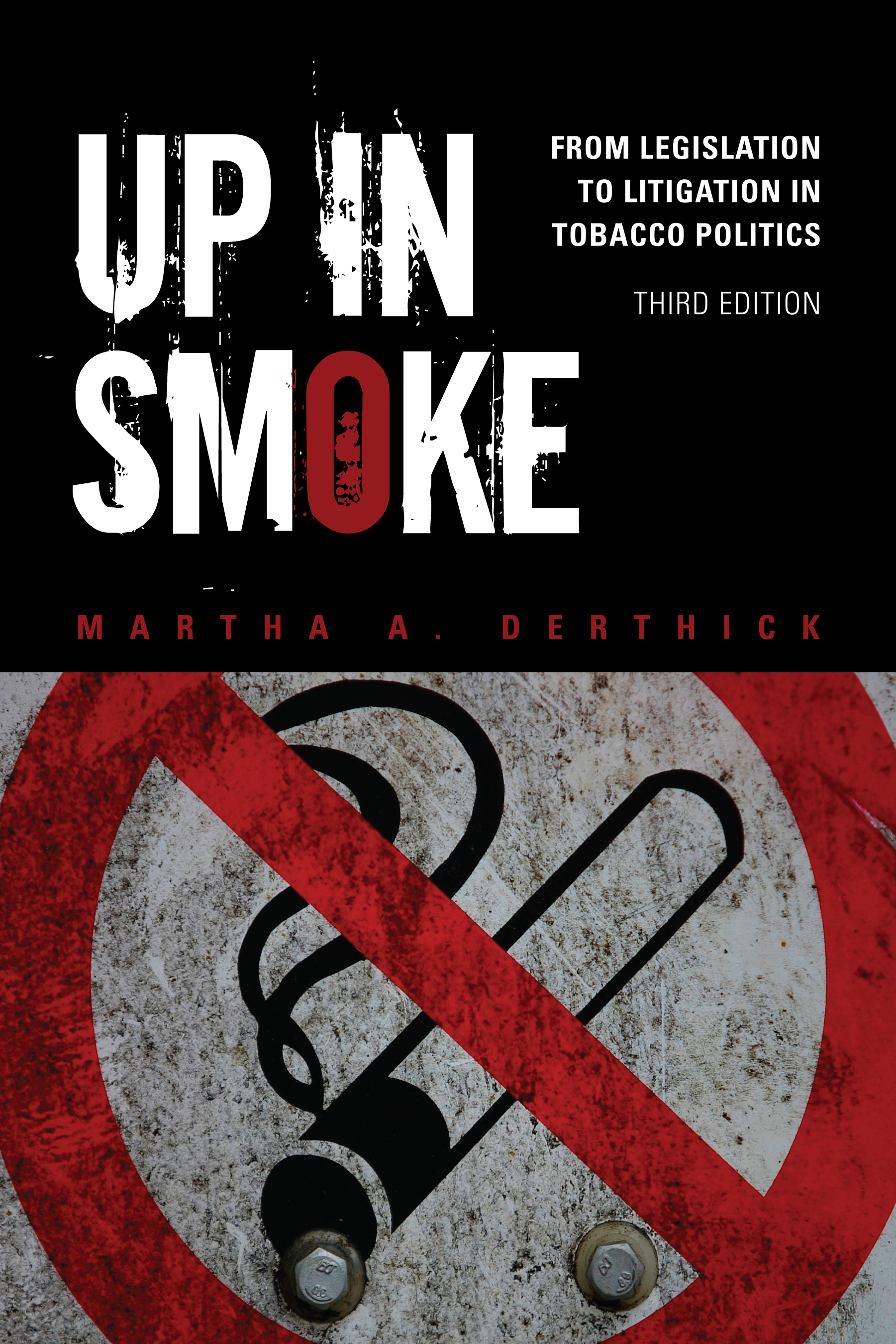
Up in Smoke Now, with a brand new 3rd edition, the book returns to "ordinary politics" and the passage of the Family Smoking Prevention and Tobacco Control Act which gave the FDA broad authority to regulate both the manufacture and marketing of tobacco products. Derthick shows our political institutions working as they should, even if slowly, with partisanship and interest group activity playing their part in putting restraints on cigarette smoking. POLITICAL SCIENCE,American Government,General

The Smear New York Times Bestseller Ever wonder how politics turned into a take-no-prisoners blood sport? The New York Times bestselling author of Stonewalled pulls back the curtain on the shady world of opposition research and reveals the dirty tricks those in power use to influence your opinions. Behind most major political stories in the modern era, there is an agenda; an effort by opposition researchers, spin doctors, and outside interests to destroy an idea or a person. The tactic they use is the Smear. Every day, Americans are influenced by the Smear without knowing it. Paid forces cleverly shape virtually every image you cross. Maybe you read that Donald Trump is a racist misogynist, or saw someone on the news mocking the Bernie Sanders campaign. The trick of the Smear is that it is often based on some shred of truth, but these media-driven "hit pieces" are designed to obscure the truth. Success hinges on the Smear artist’s ability to remain invisible; to make it seem as if their work is neither calculated nor scripted. It must appear to be precisely what it is not. Veteran journalist Sharyl Attkisson has witnessed this practice firsthand. After years of being pitched hit jobs and puff pieces, she’s an expert at detecting Smear campaigns. Now, the hard-hitting investigative reporter shares her inside knowledge, revealing how the Smear takes shape and who its perpetrators are—including Clinton confidant Sidney Blumenthal and, most influential of all, "right-wing assassin turned left-wing assassin" (National Review) political operative David Brock and his Media Matters for America empire. Attkisson exposes the diabolical tactics of Smear artists, and their outrageous access to the biggest names in political media—operatives who are corrupting the political process, and discouraging widespread citizen involvement in our democracy. POLITICAL SCIENCE,American Government,General
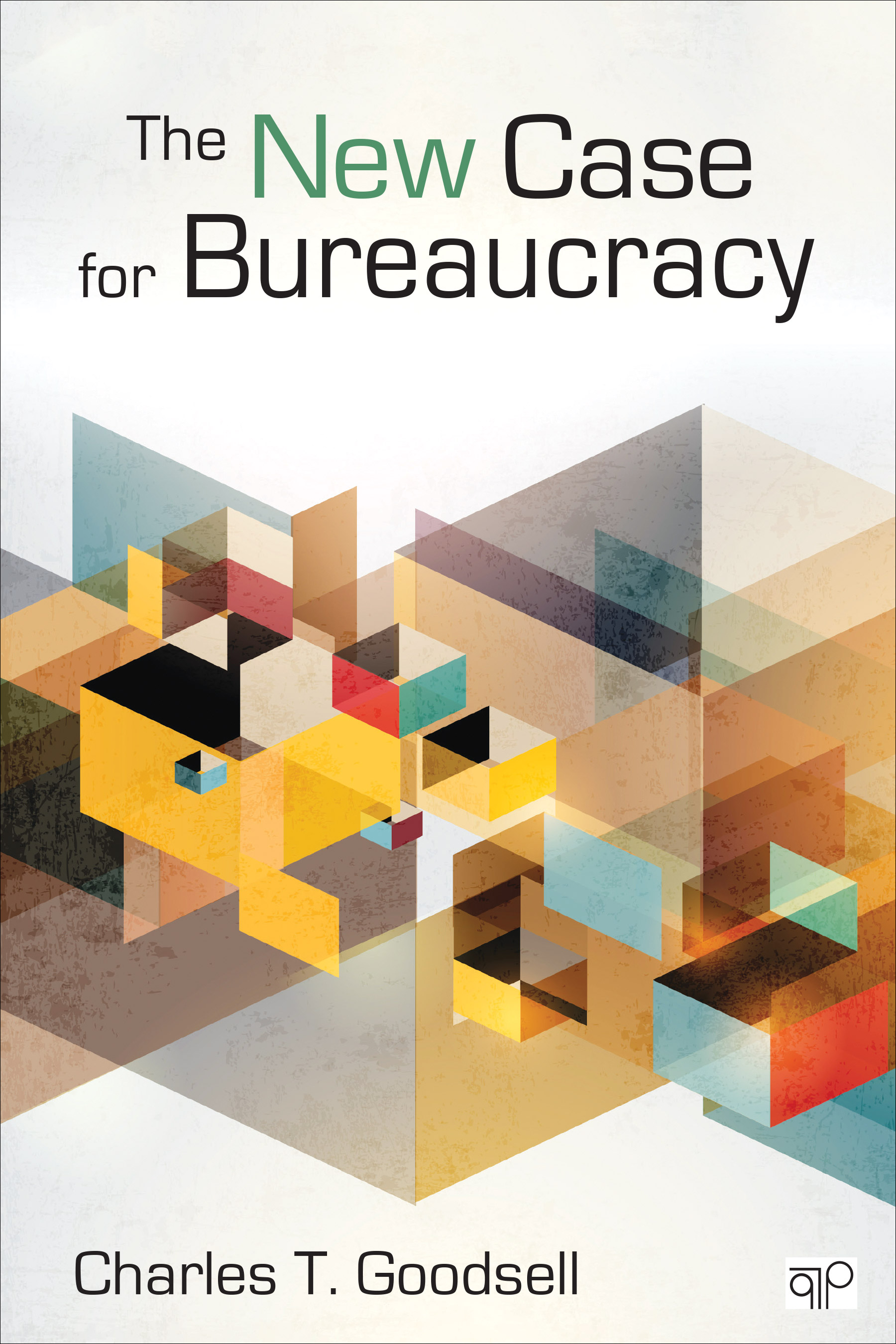
The New Case for Bureaucracy Charles Goodsell has long taken the position that U.S. bureaucracy is neither a generalized failure nor sinkhole of waste as mythologized by anti-government ideologues. Rather, it is one of the most effective and innovate sets of administrative institutions of any government in the world today. Indispensable to our democracy, it keeps government reliable and dependable to the citizens it serves. However, The New Case for Bureaucracy goes beyond empirically verifying its quality. Now an extended essay, written in a conversational tone, Goodsell expects readers to form their own judgments. At a time when Congress is locked in partisan and factional deadlock, he argues for the increased importance of bureaucrats and discusses how federal agencies must battle to keep alive in terms of resources and be strong enough to retain the integrity of their missions. POLITICAL SCIENCE,American Government,General
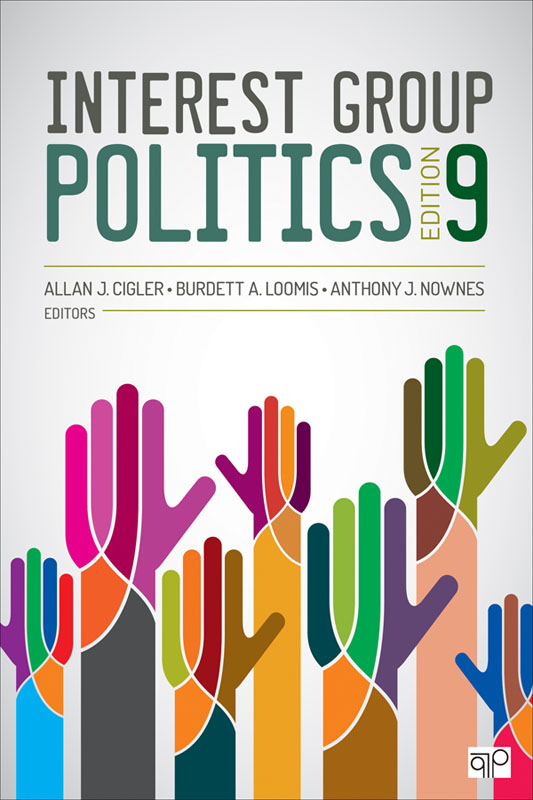
Interest Group Politics With its broad spectrum of scholarship on interest groups past and present, Interest Group Politics brings together noted political scientists to provide comprehensive coverage and cutting-edge research on the role and impact of interest groups in U.S. politics, all geared to an undergraduate audience. In the wake of the Citizens United decision and the growth of lobbying into a multi-billion dollar industry, this trusted classic provides students with a guide to the influence and reach of interest groups. The Ninth Edition offers 15 new contributions on a variety of topics including organized labor, the LGBT movement, religious lobbying, the Tea Party, the tobacco industry, the role of “dark money†in campaign funding, the profession of lobbying, and advocacy and inequality. Each chapter is written by an expert in the field and carefully edited for clarity and cohesion by the editors Allan J Cigler, Burdett A. Loomis, and Anthony J. Nownes. POLITICAL SCIENCE,American Government,General
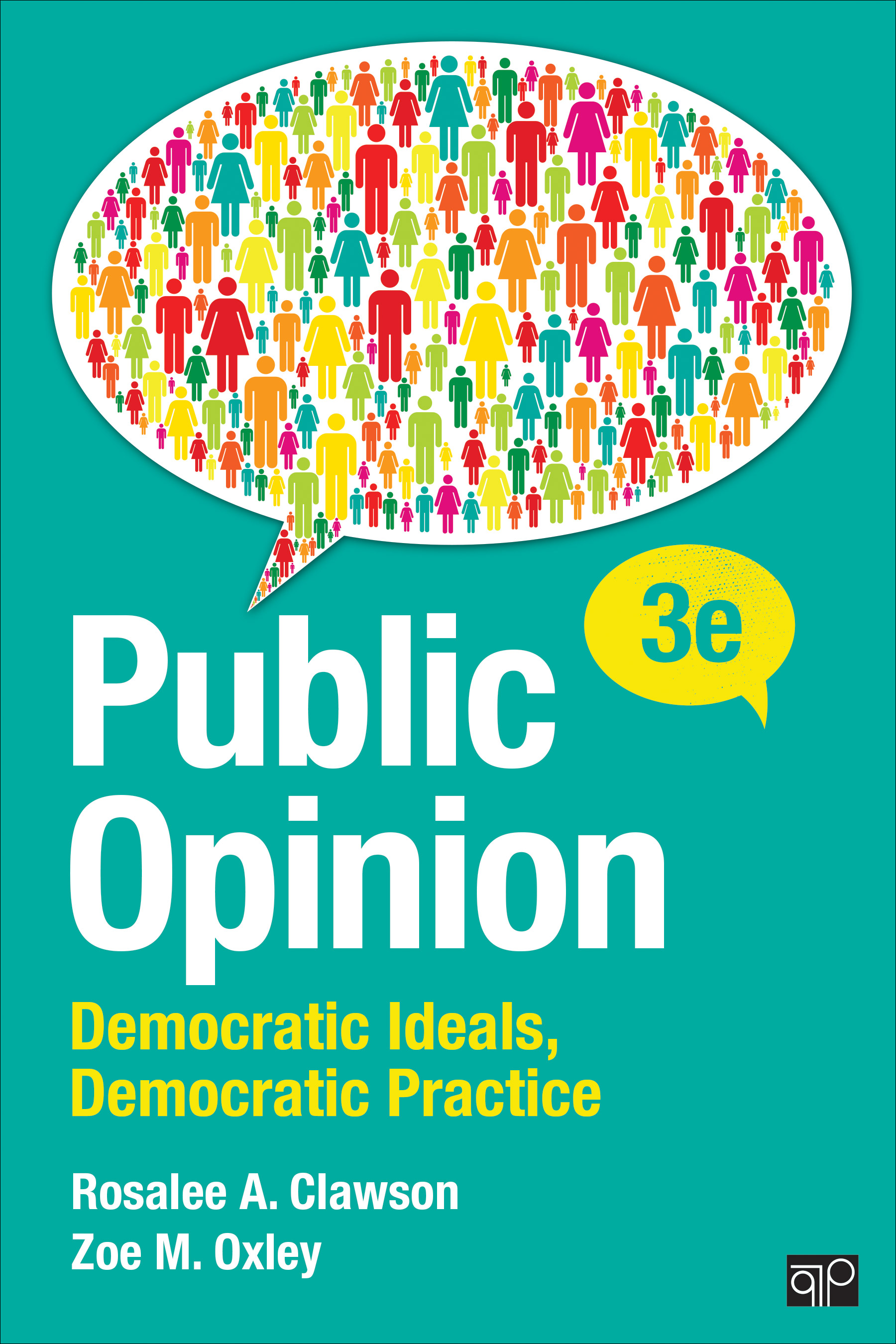
Public Opinion In this revision of their lauded Public Opinion: Democratic Ideals, Democratic Practice, Rosalee A. Clawson and Zoe M. Oxley continue to link the enduring normative questions of democratic theory to the best empirical research on public opinion. Exploring the tension between ideals and their practice, each chapter focuses on exemplary studies so that students gain a richer understanding of key findings and the research process as well as see methods applied in context. POLITICAL SCIENCE,American Government,General

American Government 101 All you need to know about elections, politics, and government! Too often, textbooks turn the noteworthy details of government into tedious discourse that would put even the president to sleep. American Government 101 cuts out the boring explanations, and instead provides a hands-on lesson that keeps you engaged as you learn. From the backstory of the Constitution to the institution of the Electoral College, this primer is packed with hundreds of entertaining tidbits and concepts to help you learn about how the government of the United States actually works. So whether you want to learn about how policies and laws are created, or just want to become a better-informed voter, American Government 101 has all the answers--even the ones you didn't know you were looking for. POLITICAL SCIENCE,American Government,General
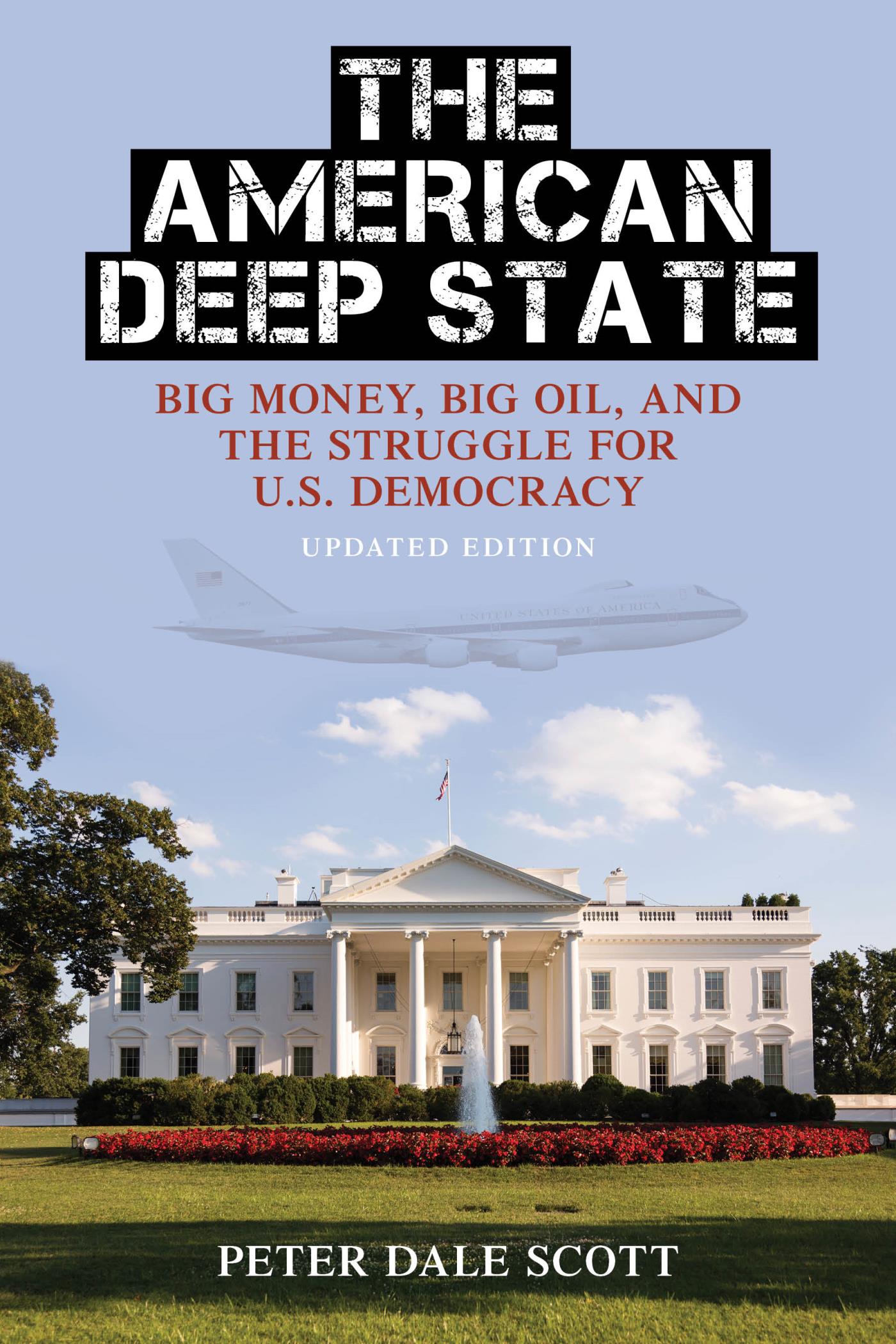
The American Deep State Now in a new edition updated through the unprecedented 2016 election, this timely book makes a compelling case for a hidden deep state of intelligence agencies, private companies, and billionaires that influence and often oppose U.S. policies. POLITICAL SCIENCE,American Government,General
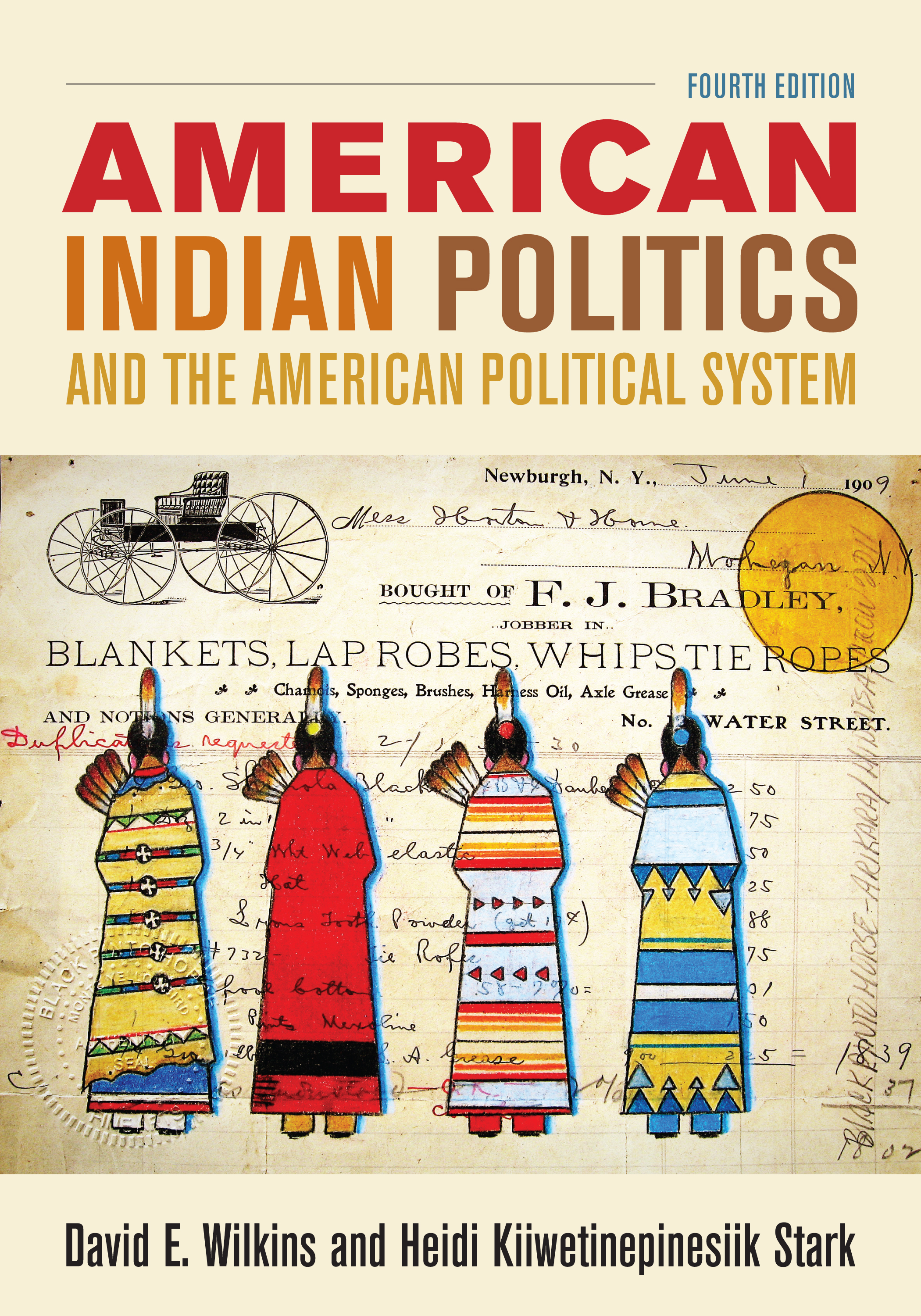
American Indian Politics and the American Political System American Indian Politics and the American Political System remains the definitive source on the structure of indigenous governments and their international relations. The text analyzes the challenges facing Indigenous nations as they develop new and innovative strategies to defend and demand recognition of their national character and rights. POLITICAL SCIENCE,American Government,General

Democracy Incorporated Democracy is struggling in America--by now this statement is almost cliché. But what if the country is no longer a democracy at all? In Democracy Incorporated, Sheldon Wolin considers the unthinkable: has America unwittingly morphed into a new and strange kind of political hybrid, one where economic and state powers are conjoined and virtually unbridled? Can the nation check its descent into what the author terms "inverted totalitarianism"? Wolin portrays a country where citizens are politically uninterested and submissive--and where elites are eager to keep them that way. At best the nation has become a "managed democracy" where the public is shepherded, not sovereign. At worst it is a place where corporate power no longer answers to state controls. Wolin makes clear that today's America is in no way morally or politically comparable to totalitarian states like Nazi Germany, yet he warns that unchecked economic power risks verging on total power and has its own unnerving pathologies. Wolin examines the myths and mythmaking that justify today's politics, the quest for an ever-expanding economy, and the perverse attractions of an endless war on terror. He argues passionately that democracy's best hope lies in citizens themselves learning anew to exercise power at the local level. Democracy Incorporated is one of the most worrying diagnoses of America's political ills to emerge in decades. It is sure to be a lightning rod for political debate for years to come. Now with a new introduction by Pulitzer Prize–winning journalist Chris Hedges, Democracy Incorporated remains an essential work for understanding the state of democracy in America. POLITICAL SCIENCE,American Government,General

Stop Mass Hysteria #1 NYT bestselling author Michael Savage calls out the mass hysteria mongers and their methods, and shows Americans that we must look to history to understand the present and avoid repeating the mistakes of the past. Since Donald Trump's historic ascendance to the presidency, American politics have reached a boiling point. Social and economic issues, even national security, have become loud, violent flashpoints for political rivals in the government, in the media and on the streets. This collective derangement has a name: mass hysteria. In his new book, Stop Mass Hysteria, #1 New York Times bestselling author Michael Savage not only deconstructs the Left's unhinged response to traditional American values like borders, language, and culture, but takes the reader on an unprecedented journey through mass hysteria's long history in the United States. From Christopher Columbus to the Salem Witch trials to the so-called "Red Scares" of the 1930s and 40s and much more, Dr. Savage recounts the many times collective insanity has gripped the American public - often prompted by sinister politicians with ulterior motives. Dr. Savage provides vital context for the common elements of dozens of outbreaks of mass hysteria in the past, their causes, their short and long-term effects, and the tactics of the puppet masters who duped gullible masses into fearing threats both real and imagined. By shining a light on the true nature and causes of American mass hysteria in the past, Savage provides an insightful look into who and what is causing dangerous unrest in our lives - and why. POLITICAL SCIENCE,American Government,General
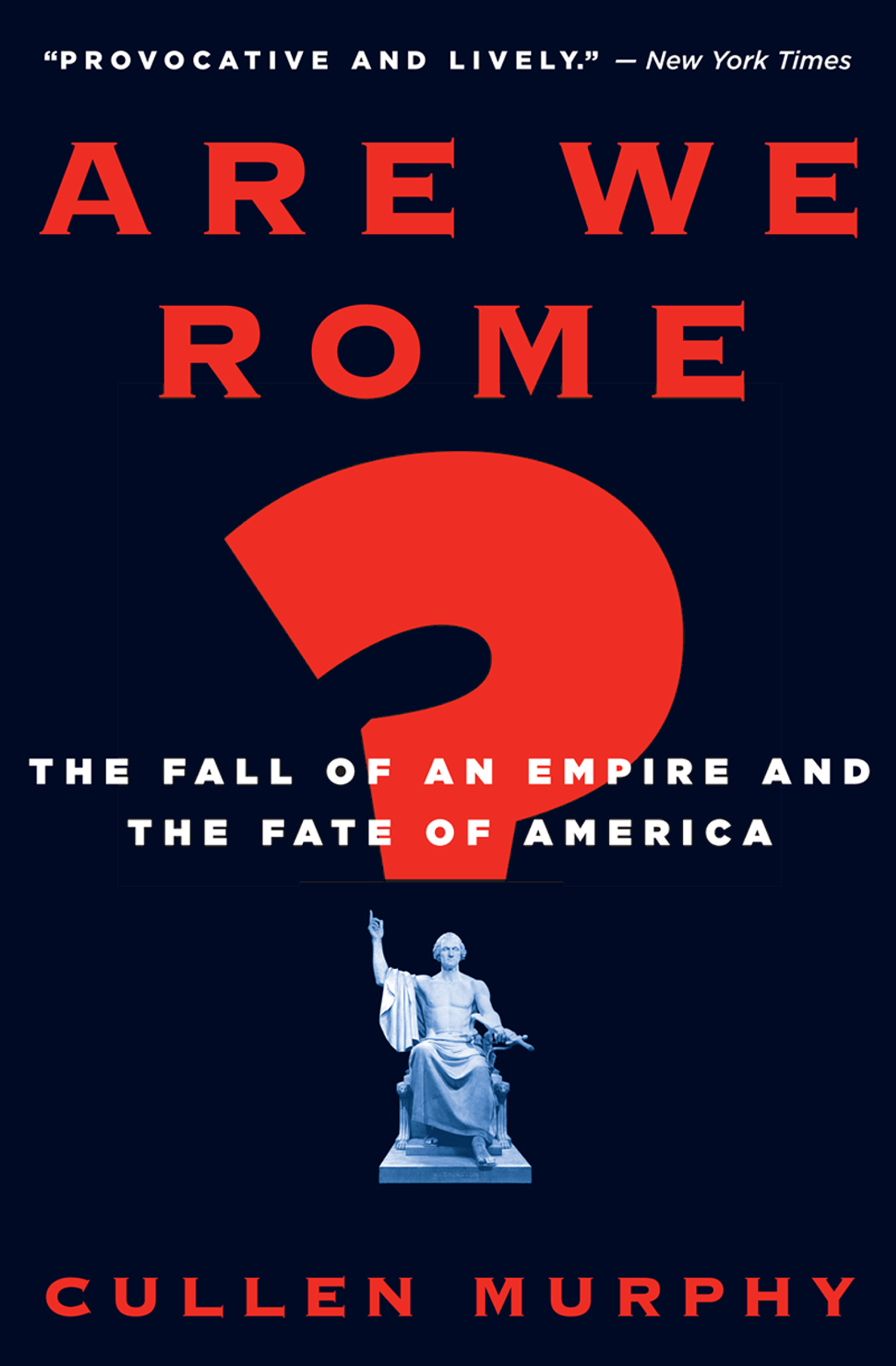
Are We Rome? What went wrong in imperial Rome, and how we can avoid it: “If you want to understand where America stands in the world today, read this.†—Thomas E. Ricks The rise and fall of ancient Rome has been on American minds since the beginning of our republic. Depending on who’s doing the talking, the history of Rome serves as either a triumphal call to action—or a dire warning of imminent collapse. In this “provocative and lively†book, Cullen Murphy points out that today we focus less on the Roman Republic than on the empire that took its place, and reveals a wide array of similarities between the two societies (The New York Times). Looking at the blinkered, insular culture of our capitals; the debilitating effect of bribery in public life; the paradoxical issue of borders; and the weakening of the body politic through various forms of privatization, Murphy persuasively argues that we most resemble Rome in the burgeoning corruption of our government and in our arrogant ignorance of the world outside—two things that must be changed if we are to avoid Rome’s fate. “Are We Rome? is just about a perfect book. . . . I wish every politician would spend an evening with this book.†—James Fallows POLITICAL SCIENCE,American Government,General

The Politically Incorrect Guide to American History “The problem in America isn’t so much what people don’t know; the problem is what people think they know that just ain’t so.†—Thomas E. Woods Most Americans trust that their history professors and high school teachers will give students honest and accurate information. The Politically Incorrect Guide to American History makes it quite clear that liberal professors have misinformed our children for generations. Professor Thomas E. Woods, Jr. takes on the most controversial moments of American history and exposes how history books are merely a series of clichés drafted by academics who are heavily biased against God, democracy, patriotism, capitalism and most American family values. Woods reveals the truth behind many of today's prominent myths.... MYTH: The First Amendment prohibits school prayer MYTH: The New Deal created great prosperity MYTH: What the Supreme Court says, goes From the real American “revolutionaries†to the reality of labor unions, The Politically Incorrect Guide to American History is all you need for the truth about America—objective and unvarnished. POLITICAL SCIENCE,American Government,General
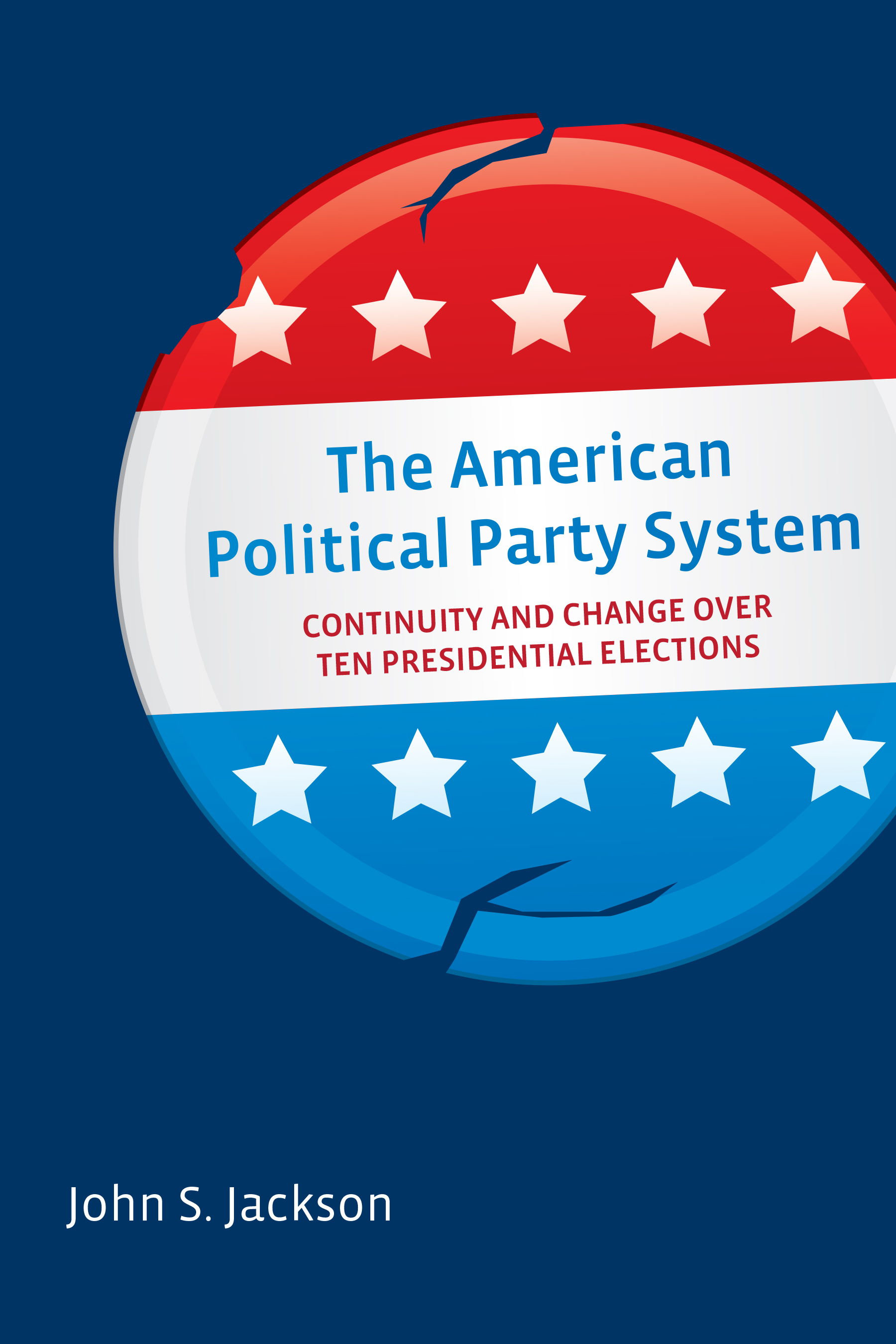
The American Political Party System From party polarization, elections, and internal party politics, to the evolution of the U.S. presidency, John S. Jackson's new book has something for everyone interested in American politics. Beginning with a discussion of the creation of the U.S. government to the formation of today's political powerhouses, Jackson provides a narrative sweep of American party history like none other. Unique to this book is a detailed breakdown of the evolution of political parties from 1832 to the current era. Jackson explains how the reform era came to be, as well as how it produced the polarized party era we have today. In doing so, he guides the reader to an appreciation of where U.S. party politics originated and the aspirations of those who helped create the current system. Jackson also examines the internal mechanisms and personalities of the Democratic and Republican parties. He compares multiple presidential elections, thus telling a broader story of the unfolding of today's party polarization and gridlock. He also explores the theoretical meaning of the changes observed in the parties from the responsible party model perspective. The themes of continuity and change are set in the context of group-think versus rational decisionmaking. Specific focus is given to political elites who are sophisticated about politics and who make strategic decisions, but are also bound by their humanity and occasionally fail to see the right deci-sion due to their own personal biases. This book will be particularly useful for those who want to explore polarization, the responsible parties model, the rational actor model, and anyone who wants to better understand elections, party politics, and the evolution of the presidency. POLITICAL SCIENCE,American Government,General
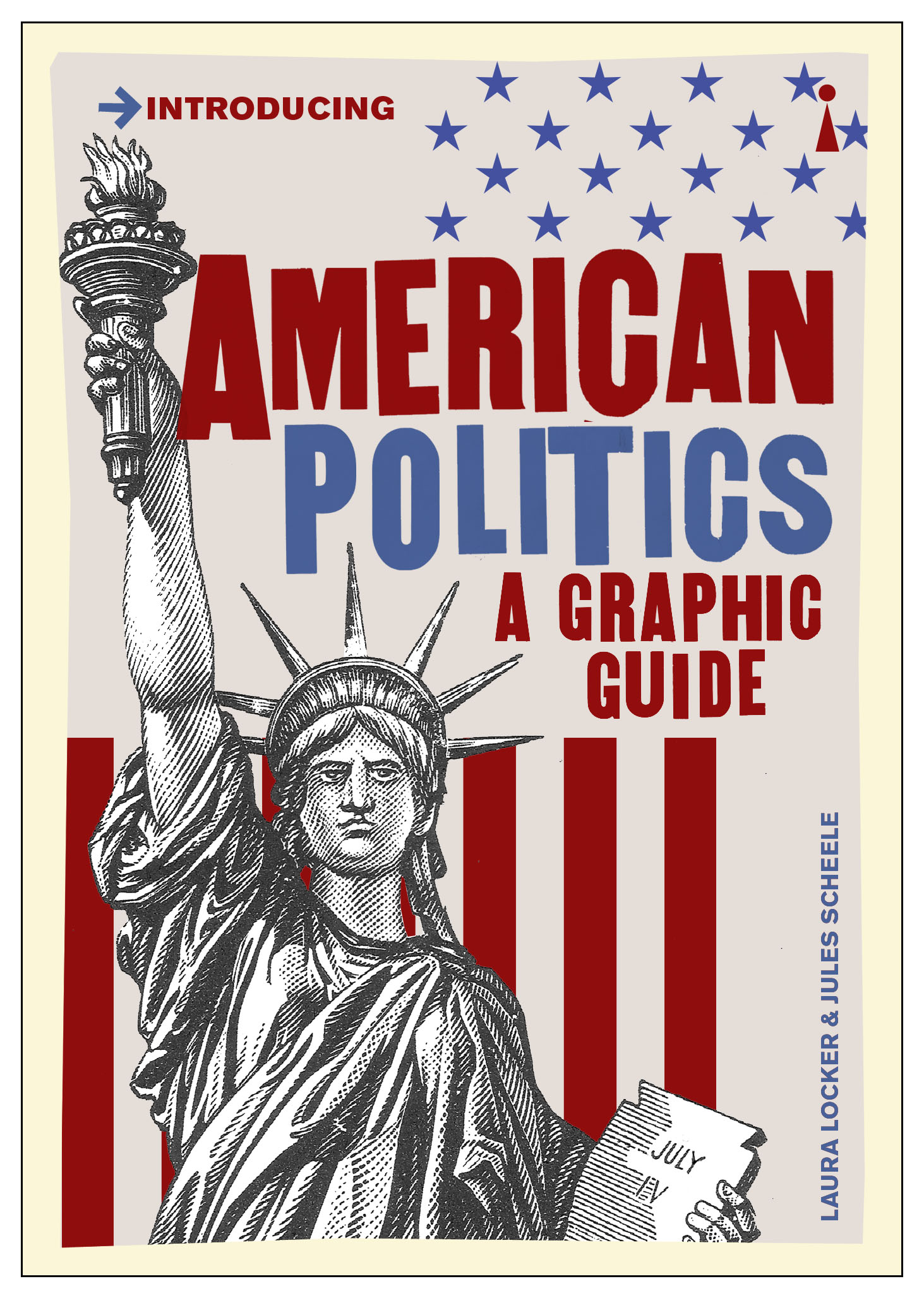
American Politics The people, ideals and events that have shaped a nation – in comic book form POLITICAL SCIENCE,American Government,General

The Infographic Guide to American Government This vibrant, illustrated guide to the ins and outs of United States politics provides a clearer understanding of the current events and regular processes that shape this nation and the world. Decipher the American political system with this clear, easy-to-understand guide to the basics of the United States political system, from the founding of the thirteen colonies, to the foundations of the constitution, to how elections work. You’ll also find information about the history and context of current issues, like how Supreme Court justices are appointed; the electoral college and the popular vote; and how to get involved in the political process. Perfect for anyone looking for information on basic political processes, The Infographic Guide to American Government includes graphics that help simplify a range of topics from the Revolutionary War to all about a free press. POLITICAL SCIENCE,American Government,General

With All Due Respect The New York Times and USA Today bestseller A revealing, dramatic, deeply personal book about the most significant events of our time, written by the former United States Ambassador to the United Nations Nikki Haley is widely admired for her forthright manner (“With all due respect, I don’t get confusedâ€), her sensitive approach to tragic events, and her confident representation of America’s interests as our Ambassador to the United Nations during times of crisis and consequence. In this book, Haley offers a first-hand perspective on major national and international matters, as well as a behind-the-scenes account of her tenure in the Trump administration. This book reveals a woman who can hold her own—and better—in domestic and international power politics, a diplomat who is unafraid to take a principled stand even when it is unpopular, and a leader who seeks to bring Americans together in divisive times. POLITICAL SCIENCE,American Government,General
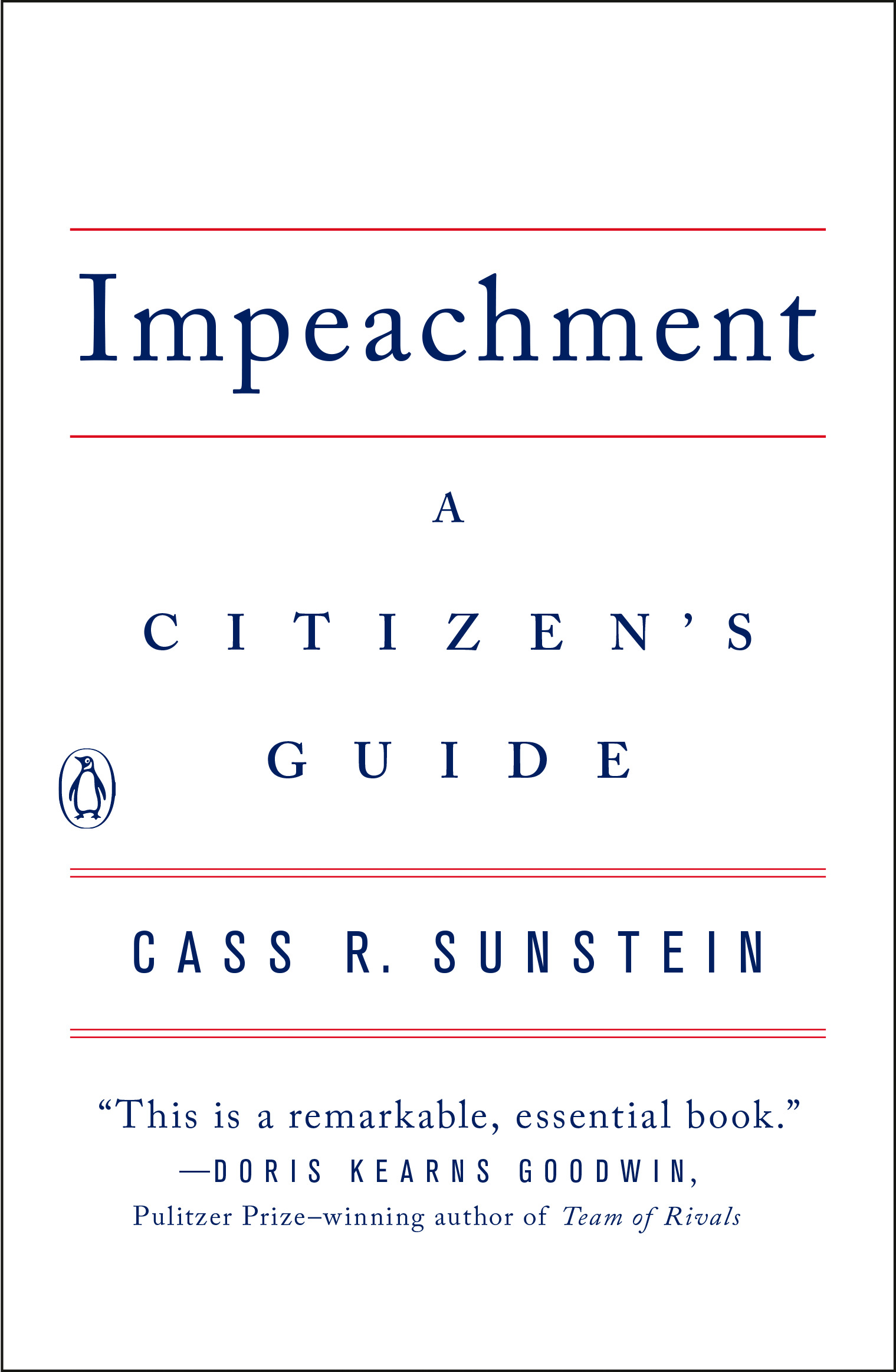
Impeachment “With insight, wisdom, affection, and concern, Sunstein has written the story of impeachment every citizen needs to know. This is a remarkable, essential book.” —Doris Kearns Goodwin No one is above the law, not even the president. Impeachment is the most potent tool the founders gave us to ensure it, and yet few of us even know how it works. As Benjamin Franklin famously put it, Americans have a republic, if we can keep it. Preserving the Constitution and the democratic system it supports is the public's responsibility. One route the Constitution provides for discharging that duty--a route rarely traveled--is impeachment. Expanding beyond violations of the law, impeachment was meant to defend against any action that would undermine the foundations of our republic. Harvard Law professor Cass R. Sunstein provides a succinct citizen's guide to this essential tool of self-government. Taking us deeper than mere partisan politics, he illuminates the constitutional design behind impeachment and emphasizes the people's role in holding presidents accountable. In spite of the loud national debate over whether or not the House is right to impeach Trump, impeachment itself remains widely misunderstood. Sunstein identifies and corrects a number of common misconceptions, and describes how impeachment helps is an essential piece of our constitutional order, and a crucial part of the framers' decision to install an empowered executive in a nation deeply fearful of kings. With an eye toward the past and the future, Impeachment: A Citizen's Guide considers a host of actual and imaginable arguments for a president's removal, explaining why some cases are easy and others hard, why some arguments for impeachment have been judicious and others not. And with an afterword and appendix on the current impeachment, it puts the national debate in its proper historical context. In direct and approachable terms, it is a guide through the treacherous waters of the impeachment process so that Americans of all political convictions may use their ultimate civic authority wisely. POLITICAL SCIENCE,American Government,General
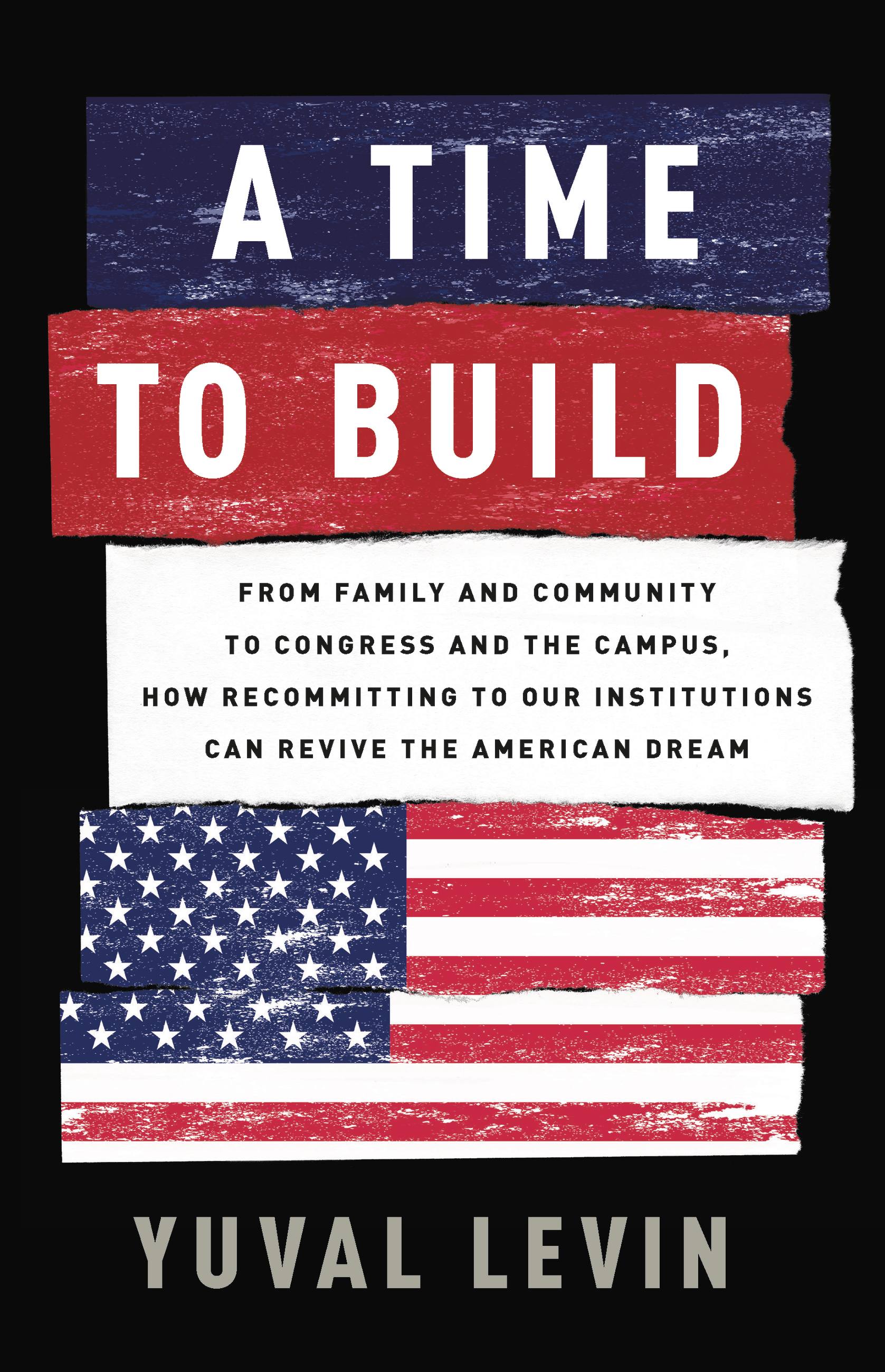
A Time to Build A leading conservative intellectual argues that to renew America we must recommit to our institutions Americans are living through a social crisis. Our politics is polarized and bitterly divided. Culture wars rage on campus, in the media, social media, and other arenas of our common life. And for too many Americans, alienation can descend into despair, weakening families and communities and even driving an explosion of opioid abuse. Left and right alike have responded with populist anger at our institutions, and use only metaphors of destruction to describe the path forward: cleaning house, draining swamps. But, as Yuval Levin argues, this is a misguided prescription, rooted in a defective diagnosis. The social crisis we confront is defined not by an oppressive presence but by a debilitating absence of the forces that unite us and militate against alienation. As Levin argues, now is not a time to tear down, but rather to build and rebuild by committing ourselves to the institutions around us. From the military to churches, from families to schools, these institutions provide the forms and structures we need to be free. By taking concrete steps to help them be more trustworthy, we can renew the ties that bind Americans to one another. POLITICAL SCIENCE,American Government,General
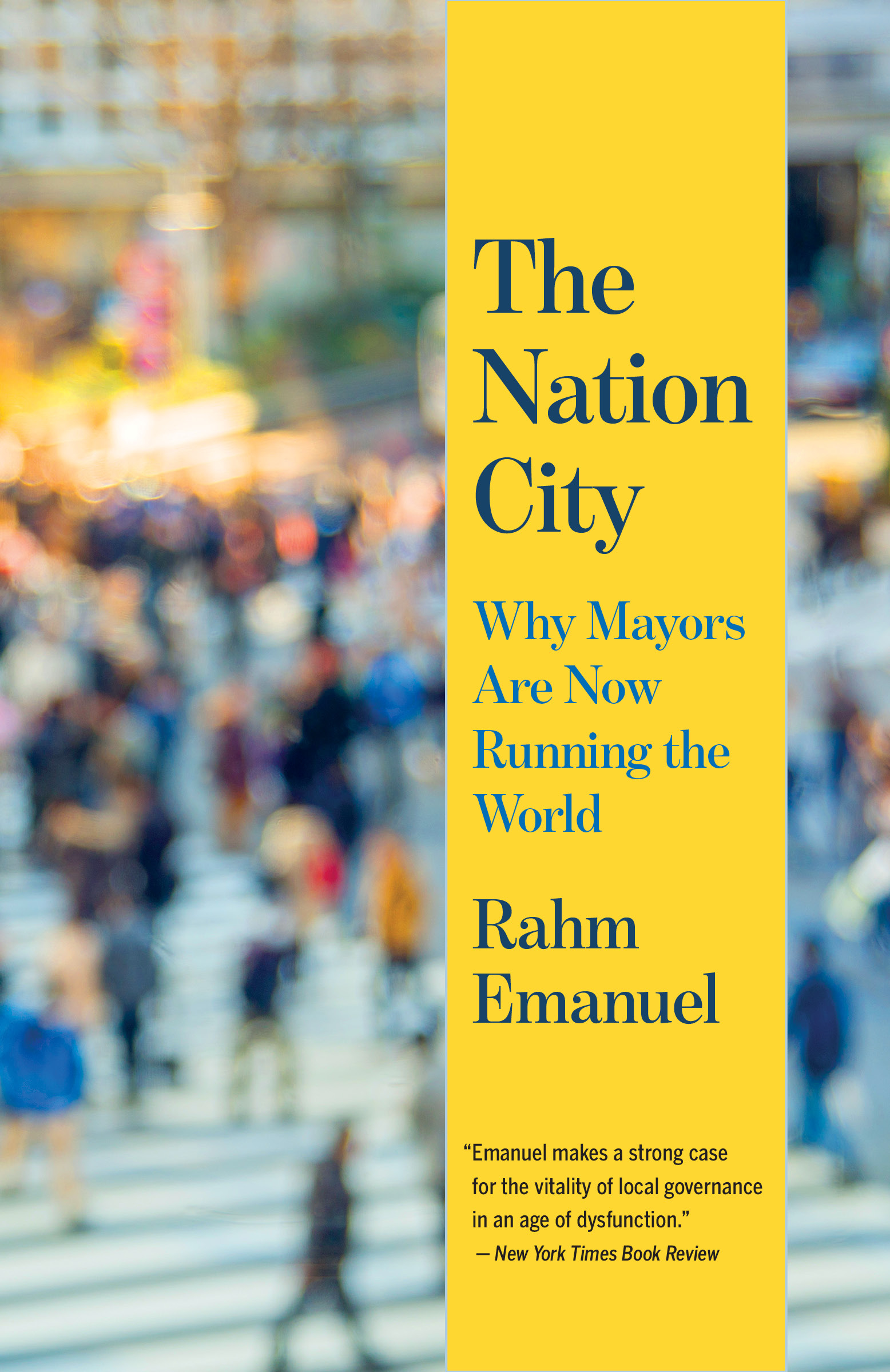
The Nation City At a time of anxiety about the effectiveness of our national government, Rahm Emanuel provides a clear vision, for both progressives and centrists, of how to get things done in America today--a bracing, optimistic vision of America's future from one of our most experienced and original political minds. In The Nation City, Rahm Emanuel, former two-term mayor of Chicago and White House Chief of Staff for President Barack Obama, offers a firsthand account of how cities, rather than the federal government, stand at the center of innovation and effective governance. Drawing on his own experiences in Chicago, and on his relationships with other mayors around America, Emanuel provides dozens of examples to show how cities are improving education, infrastructure, job conditions, and environmental policy at a local level. Emanuel argues that cities are the most ancient political institutions, dating back thousands of years and have reemerged as the nation-states of our time. He makes clear how mayors are accountable to their voters to a greater degree than any other elected officials and illuminates how progressives and centrists alike can best accomplish their goals by focusing their energies on local politics. The Nation City maps out a new, energizing, and hopeful way forward. POLITICAL SCIENCE,American Government,General

The American Trap In 2014, France lost part of the control of its nuclear power plants to the United States. Frédéric Pierucci, former senior executive of one of Alstom's power company subsidiaries, found himself at the heart of this state scandal. His story goes to the very core of how he plotted the key features of the secret economic war that the United States is waging in Europe. And after being silenced for a long time, he has decided, with the help of journalist Matthieu Aron, to reveal all. In April 2013, Frédéric Pierucci was arrested in New York by the FBI and accused of bribery. The US authorities imprisoned him for more than two years - including fourteen months in a notorious maximum-security prison. In doing so, they forced Alstom to pay the biggest financial penalty ever imposed by the United States. In the end, Alstom also gave up areas of control to General Electric, its biggest American competitor. Frédéric's story unpacks how the United States is using corporate law as an economic weapon against its own allies. One after the other, some of the world's largest companies are being actively destabilised to the benefit of the US, in acts of economic sabotage that seem to be the beginning of what's to come... POLITICAL SCIENCE,American Government,General
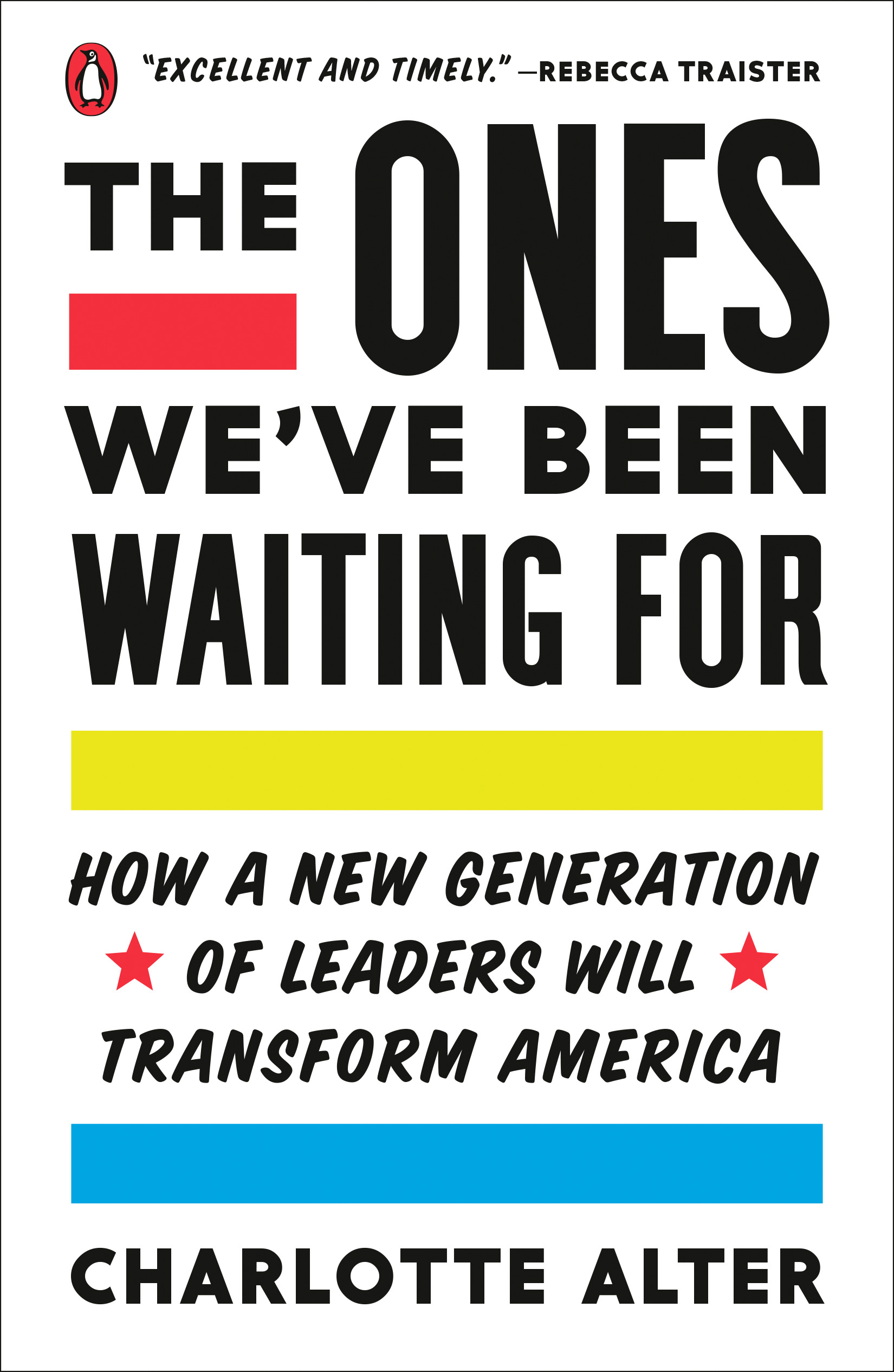
The Ones We've Been Waiting For An optimistic look at the future of American leadership by a brilliant young reporter A new generation is stepping up. There are now twenty-six millennials in Congress--a fivefold increase gained in the 2018 midterms alone. They are governing Midwestern cities and college towns, running for city councils, and serving in state legislatures. They are acting urgently on climate change (because they are going to live it); they care deeply about student debt (because they have it); they are utilizing big tech but still want to regulate it (because they understand how it works). In The Ones We've Been Waiting For, TIME correspondent Charlotte Alter defines the class of young leaders who are remaking the nation--how grappling with 9/11 as teens, serving in Iraq and Afghanistan, occupying Wall Street and protesting with Black Lives Matter, and shouldering their way into a financially rigged political system has shaped the people who will govern the future. Through the experiences of millennial leaders--from progressive firebrand Alexandria Ocasio-Cortez to Democratic presidential hopeful Pete Buttigieg to Republican up-and-comer Elise Stefanik--Charlotte Alter gives the big-picture look at how this generation governs differently than their elders, and how they may drag us out of our current political despair. Millennials have already revolutionized technology, commerce, and media and have powered the major social movements of our time. Now government is ripe for disruption. The Ones We've Been Waiting For is a hopeful glimpse into a bright new generation of political leaders, and what America might look like when they are in charge. POLITICAL SCIENCE,American Government,General
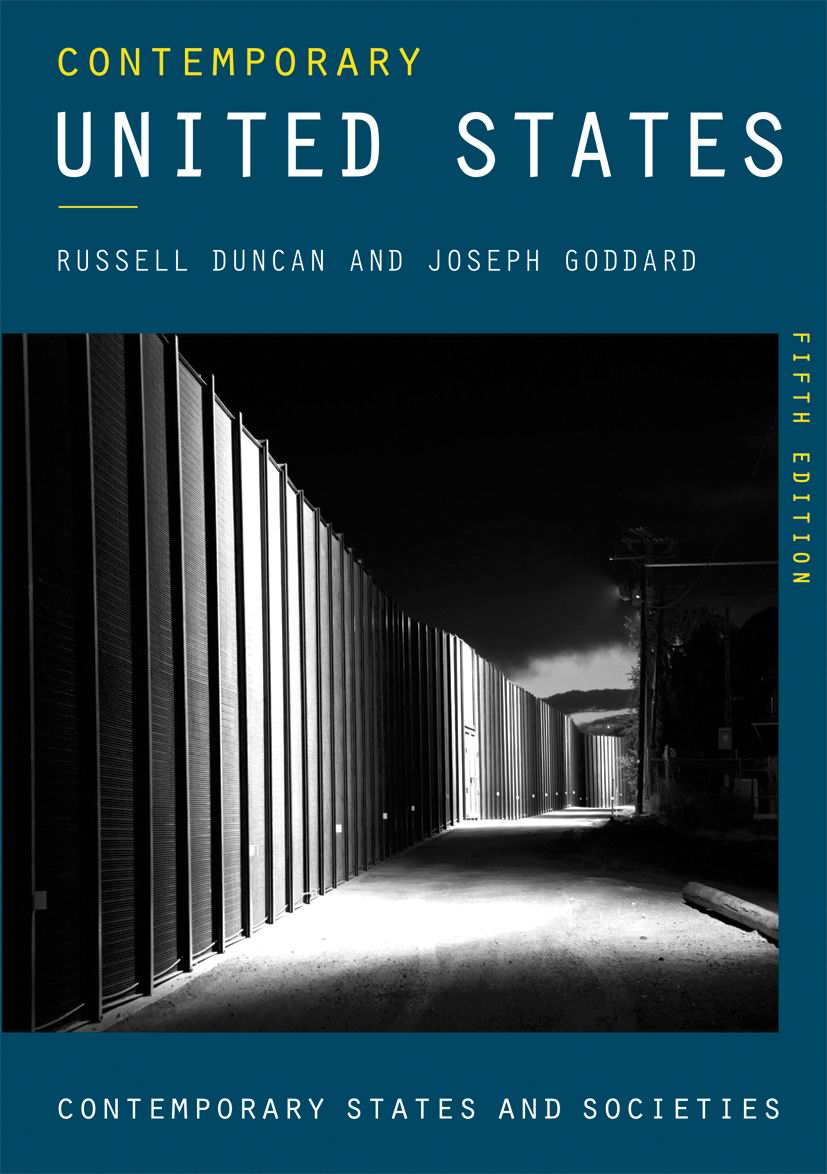
Contemporary United States A new fifth edition of a well-established and popular introduction to all aspects of life in the US, fully updated to take into account the latest key domestic and international developments. Making use of a wide range of data and illustrative material, this cutting-edge analysis looks back on the accomplishments of Obama, discusses the first year of Trump, and reconsiders the role of US in a changing world. This is a natural choice for any module convenor seeking a broad and up-to-date text which provides an overview of a country that continues to provide fascination for many students. It is essential reading for those taking modules on contemporary America across degree programmes in American Studies and Civilization, English Studies, History, Sociology and Politics. POLITICAL SCIENCE,American Government,General
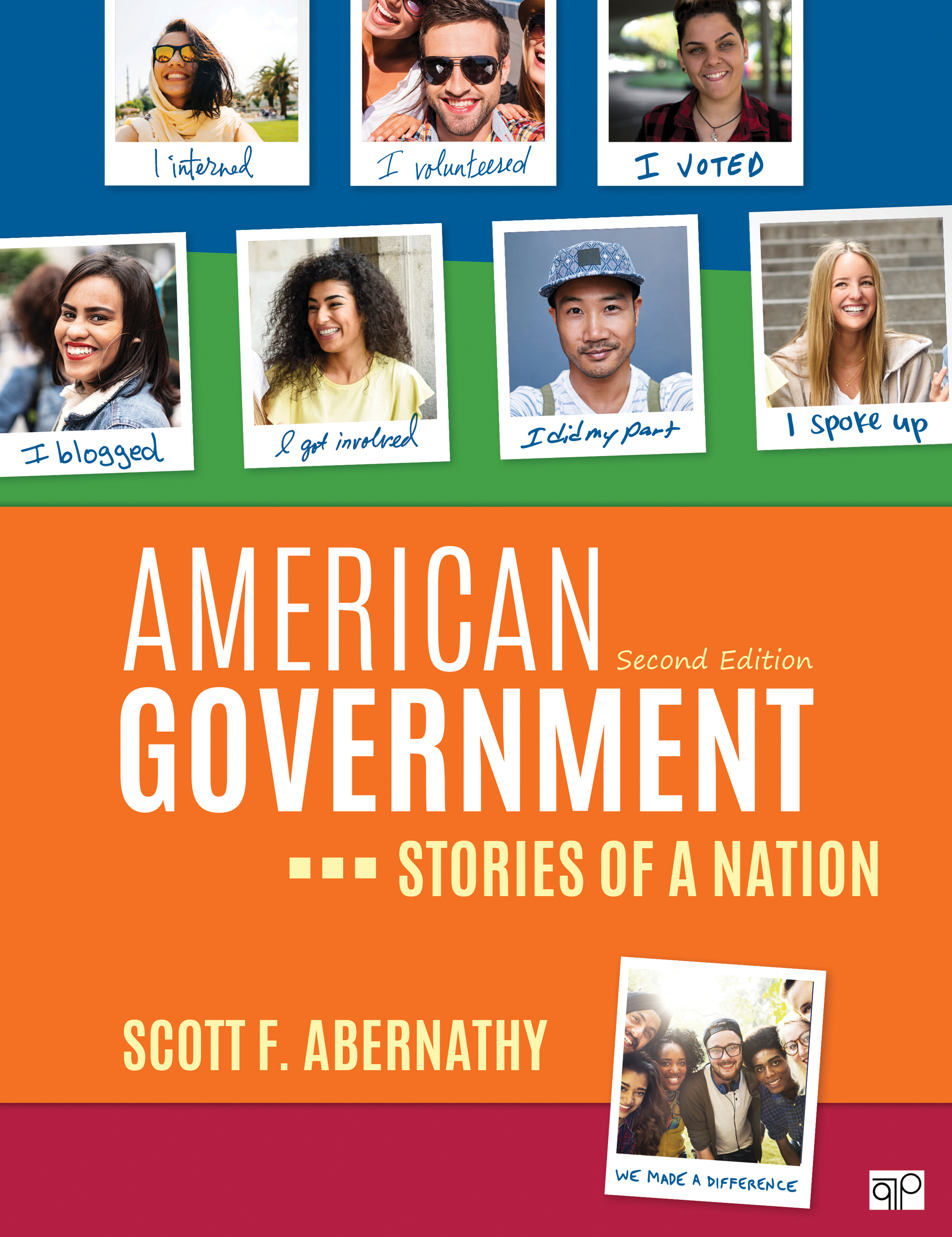
American Government In the Second Edition of American Government, author Scott F. Abernathy tunes in to the voices of all Americans, showing how our diverse ideas shape the way we participate and behave, the laws we live by, and the challenges we face. From the Constitutional Convention to Ferguson, Missouri, each chapter features rich, personal narratives that illustrate how the American political system is the product of strategies, calculations, and miscalculations of countless individuals. It focuses on real people, the actions they take, the struggles they face, and how their choices influence outcomes. The key concepts are memorable because they are tied to real politics, where students see political action and political choices shaping how institutions advance or impede the fulfillment of fundamental ideas. Participation is at the heart of this groundbreaking new text, with ample background on how and why to participate. Not only will all students see themselves reflected in the pages, but they will come to understand that they, too, are strategic players in American politics, with voices that matter. Also available as a digital option (courseware) . Contact your rep to learn more about American Government, Second Edition - Vantage Digital Option. POLITICAL SCIENCE,American Government,General
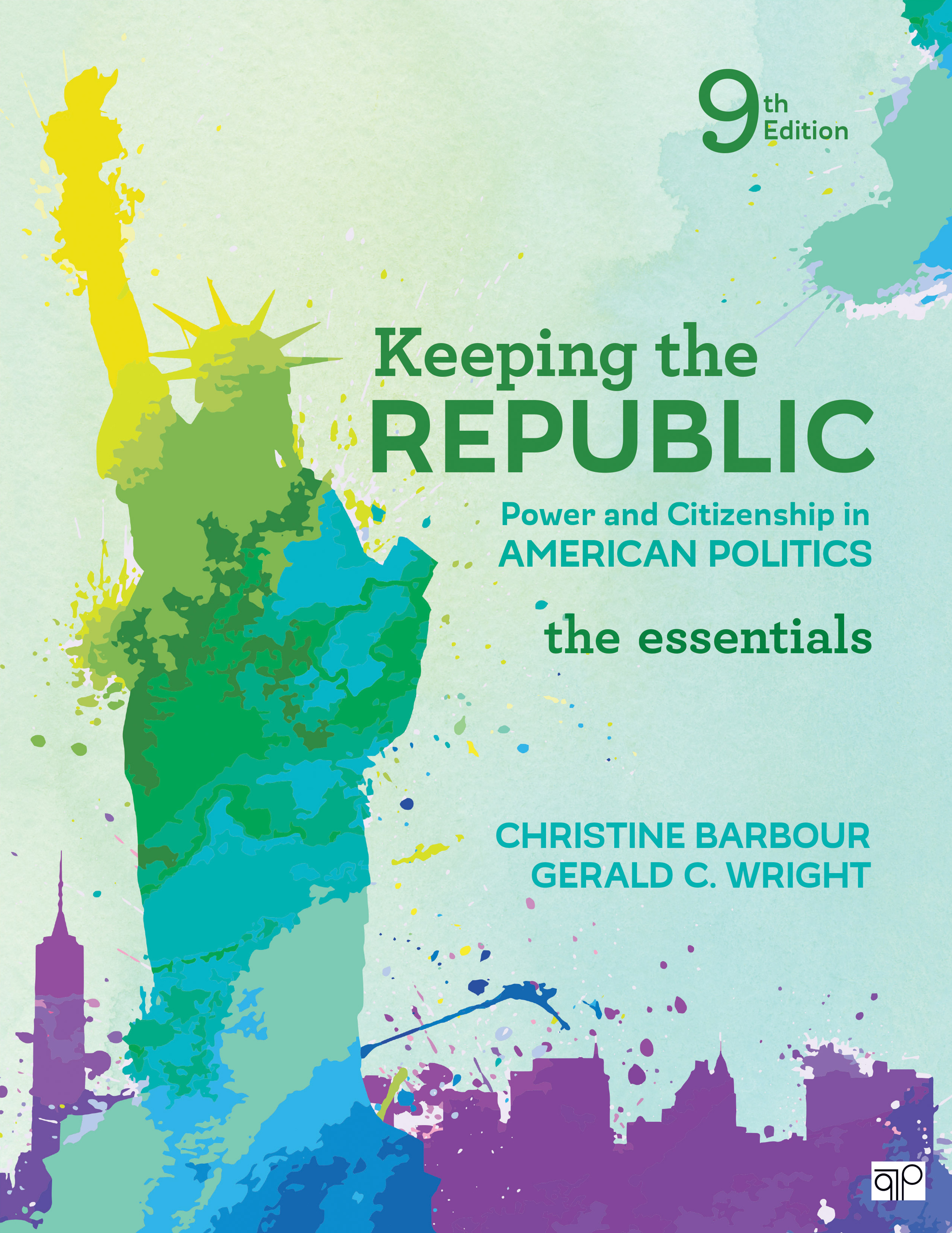
Keeping the Republic Keeping the Republic gives students the power to examine the narrative of what's going on in American politics, distinguish fact from fiction and balance from bias, and influence the message through informed citizenship. Keeping the Republic draws students into the study of American politics, showing them how to think critically about “who gets what, and how†while exploring the twin themes of power and citizenship. Students are pushed to consider how and why institutions and rules determine who wins and who loses in American politics, and to be savvy consumers of political information. The thoroughly updated Ninth Edition considers how a major component of power is who controls the information, how it is assembled into narratives, and whether we come to recognize fact from fiction. Citizens now have unprecedented access to power – the ability to create and share their own narratives – while simultaneously being even more vulnerable to those trying to shape their views. The political landscape of today gives us new ways to keep the republic, and some high-tech ways to lose it. Throughout the text and its features, authors Christine Barbour and Gerald Wright show students how to effectively apply the critical thinking skills they develop to the political information they encounter every day. Students are challenged to deconstruct prevailing narratives and effectively harness the political power of the information age for themselves. Up-to-date with 2018 election results and analysis, as well as the impact of recent Supreme Court rulings, shifting demographics, and emerging and continuing social movements, Keeping the Republic, Ninth Edition is a much-needed resource to help students make sense of politics in America today. Keeping the Republic, The Essentials is identical to the full version of the text, minus the three policy chapters. Also available as a digital option (courseware) . Contact your rep to learn more about Keeping the Republic, Ninth Essentials Edition - Vantage Digital Option. POLITICAL SCIENCE,American Government,General
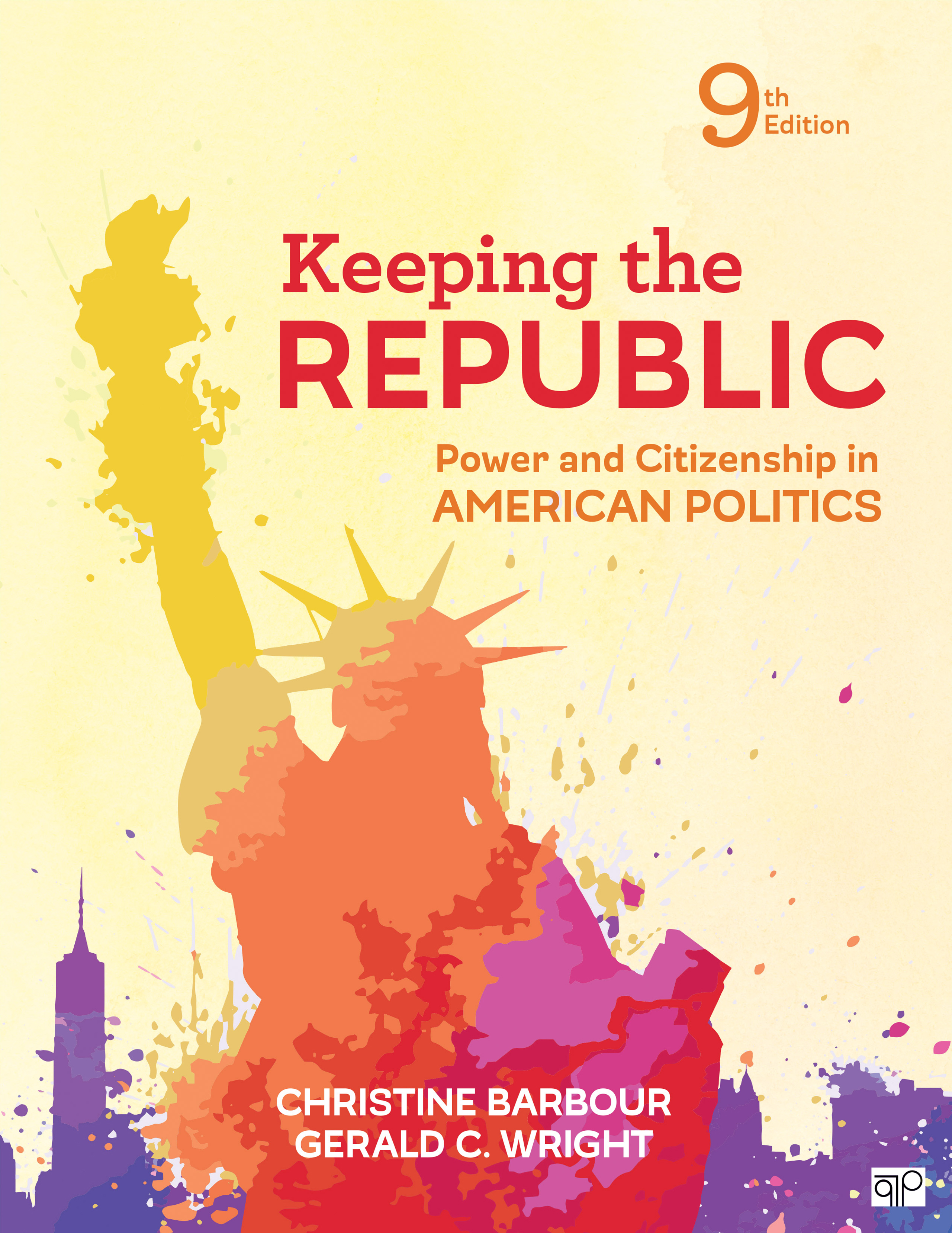
Keeping the Republic Keeping the Republic gives students the power to examine the narrative of what's going on in American politics, distinguish fact from fiction and balance from bias, and influence the message through informed citizenship. Keeping the Republic draws students into the study of American politics, showing them how to think critically about “who gets what, and how†while exploring the twin themes of power and citizenship. Students are pushed to consider how and why institutions and rules determine who wins and who loses in American politics, and to be savvy consumers of political information. The thoroughly updated Ninth Edition considers how a major component of power is who controls the information, how it is assembled into narratives, and whether we come to recognize fact from fiction. Citizens now have unprecedented access to power – the ability to create and share their own narratives – while simultaneously being even more vulnerable to those trying to shape their views. The political landscape of today gives us new ways to keep the republic, and some high-tech ways to lose it. Throughout the text and its features, authors Christine Barbour and Gerald Wright show students how to effectively apply the critical thinking skills they develop to the political information they encounter every day. Students are challenged to deconstruct prevailing narratives and effectively harness the political power of the information age for themselves. Up-to-date with 2018 election results and analysis, as well as the impact of recent Supreme Court rulings, shifting demographics, and emerging and continuing social movements, Keeping the Republic, Ninth Edition is a much-needed resource to help students make sense of politics in America today. Also available as a digital option (courseware) . Contact your rep to learn more about Keeping the Republic, Ninth Edition - Vantage Digital Option. POLITICAL SCIENCE,American Government,General
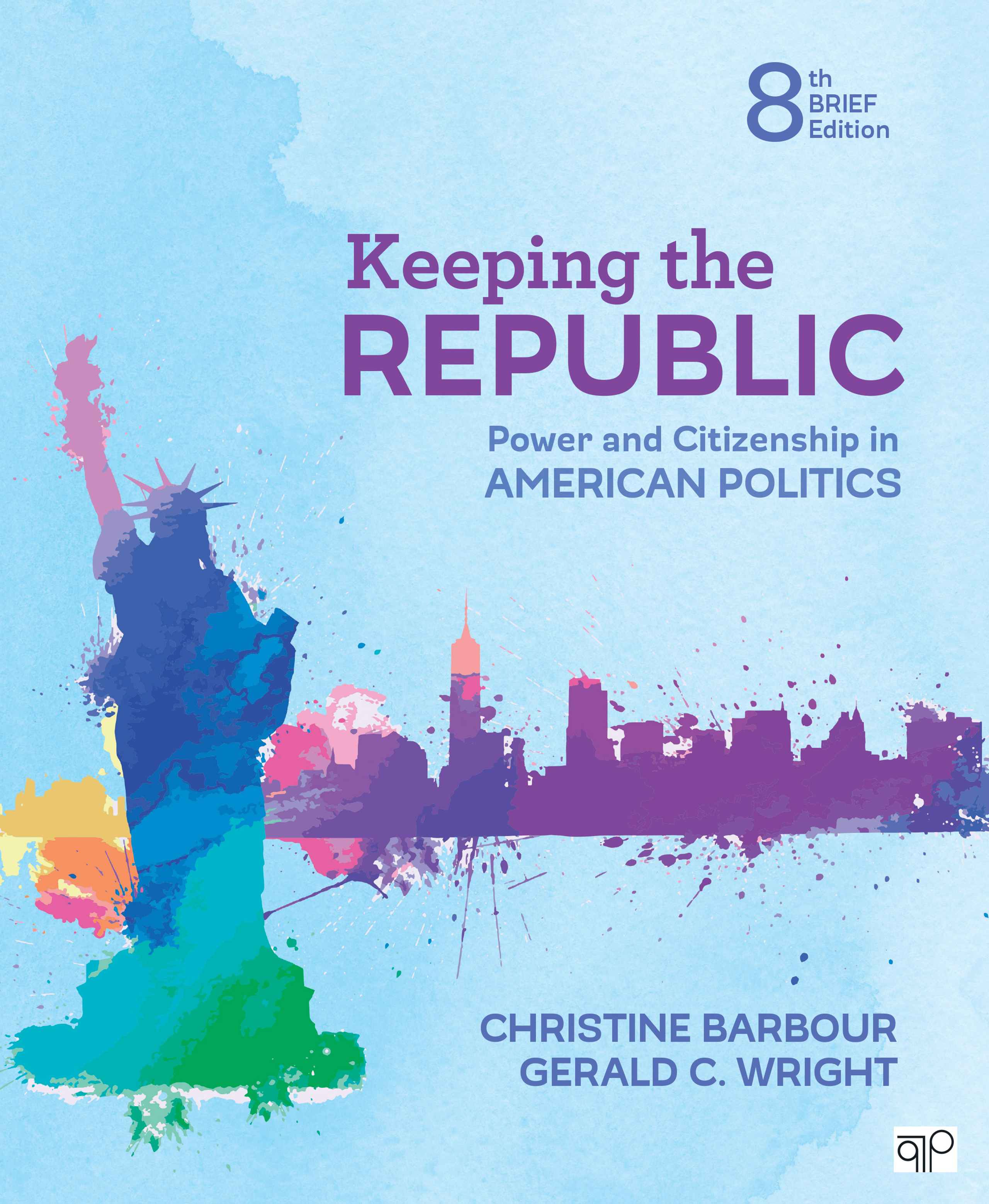
Keeping the Republic Keeping the Republic gives students the power to examine the narrative of what's going on in American politics, distinguish fact from fiction and balance from bias, and influence the message through informed citizenship. Keeping the Republic draws students into the study of American politics, showing them how to think critically about “who gets what, and how†while exploring the twin themes of power and citizenship. Students are pushed to consider how and why institutions and rules determine who wins and who loses in American politics, and to be savvy consumers of political information. The thoroughly updated Eighth Edition considers how a major component of power is who controls the information, how it is assembled into narratives, and whether we come to recognize fact from fiction. Citizens now have unprecedented access to power – the ability to create and share their own narratives – while simultaneously being even more vulnerable to those trying to shape their views. The political landscape of today gives us new ways to keep the republic, and some high-tech ways to lose it. Throughout the text and its features, authors Christine Barbour and Gerald Wright show students how to effectively apply the critical thinking skills they develop to the political information they encounter every day. Students are challenged to deconstruct prevailing narratives and effectively harness the political power of the information age for themselves. Up-to-date with 2018 election results and analysis, as well as the impact of recent Supreme Court rulings, shifting demographics, and emerging and continuing social movements, Keeping the Republic, Eighth Edition is a much-needed resource to help students make sense of politics in America today. Carefully condensed from the full version by authors Christine Barbour and Gerald Wright, Keeping the Republic, Brief Edition gives your students all the continuity and crucial content, in a more concise, value-oriented package. Also available as a digital option (courseware) . Contact your rep to learn more about Keeping the Republic, Eighth Brief Edition - Vantage Digital Option. POLITICAL SCIENCE,American Government,General

The Logic of American Politics Why does the American political system work the way it does? Find the answers in The Logic of American Politics. This best-selling text arms you with a toolkit of institutional design concepts—command, veto, agenda control, voting rules, and delegation—that help you recognize how the American political system was designed and why it works the way it does. The authors build your critical thinking through a simple yet powerful idea: politics is about solving collective action problems. Thoroughly updated to account for the most recent events and data, the Ninth Edition explores the increase in political polarization, the growing emotional involvement people have to politics, Americans’ reactions to changing demographics, the partisan politics of judicial selection, and the changing nature of presidential leadership. Revised to include the 2018 election results and analysis, this edition provides you with the tools you need to make sense of today’s government. POLITICAL SCIENCE,American Government,General
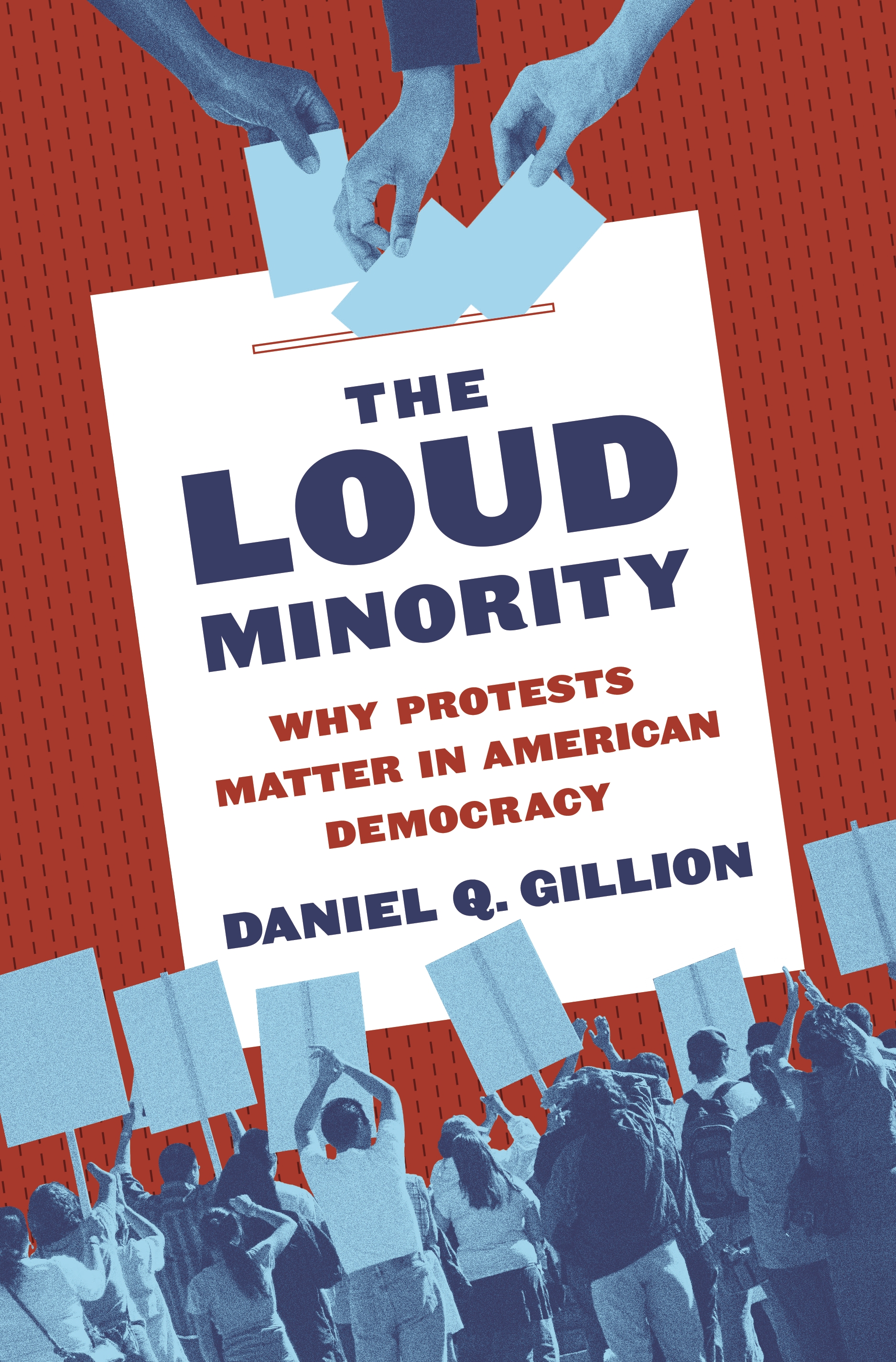
The Loud Minority How political protests and activism have a direct influence on voter and candidate behavior The “silent majorityâ€â€”a phrase coined by Richard Nixon in 1969 in response to Vietnam War protests and later used by Donald Trump as a campaign slogan—refers to the supposed wedge that exists between protestors in the street and the voters at home. The Loud Minority upends this view by demonstrating that voters are in fact directly informed and influenced by protest activism. Consequently, as protests grow in America, every facet of the electoral process is touched by this loud minority, benefiting the political party perceived to be the most supportive of the protestors’ messaging. Drawing on historical evidence, statistical data, and detailed interviews about protest activity since the 1960s, Daniel Gillion shows that electoral districts with protest activity are more likely to see increased voter turnout at the polls. Surprisingly, protest activities are also moneymaking endeavors for electoral politics, as voters donate more to political candidates who share the ideological leanings of activists. Finally, protests are a signal of political problems, encouraging experienced political challengers to run for office and hurting incumbents’ chances of winning reelection. The silent majority may not speak by protesting themselves, but they clearly gesture for social change with their votes. An exploration of how protests affect voter behavior and warn of future electoral changes, The Loud Minority looks at the many ways that activism can shape democracy. POLITICAL SCIENCE,American Government,General

The System From the best-selling author of Saving Capitalism and The Common Good, an urgent analysis of how the "rigged" systems of American politics and power operate, how this status quo came to be, and how average citizens can enact change. Millions of Americans have lost confidence in our political and economic system. After years of stagnant wages, volatile job markets, and an unwillingness by those in power to deal with profound threats such as climate change, there is a mounting sense that the system is fixed, serving only those select few with enough money to secure a controlling stake. With the characteristic clarity and passion that has made him a central civil voice, Robert B. Reich shows how wealth and power have interacted to install an elite oligarchy, eviscerate the middle class, and undermine democracy. Using Jamie Dimon, the chairman and CEO of JPMorgan Chase as an example, Reich exposes how those at the top propagate myths about meritocracy, national competitiveness, corporate social responsibility, and the "free market" to distract most Americans from their accumulation of extraordinary wealth, and power over the system. Instead of answering the call to civic duty, they have chosen to uphold self-serving policies that line their own pockets and benefit their bottom line. Reich's objective is not to foster cynicism, but rather to demystify the system so that we might instill fundamental change and demand that democracy works for the majority once again. POLITICAL SCIENCE,American Government,General
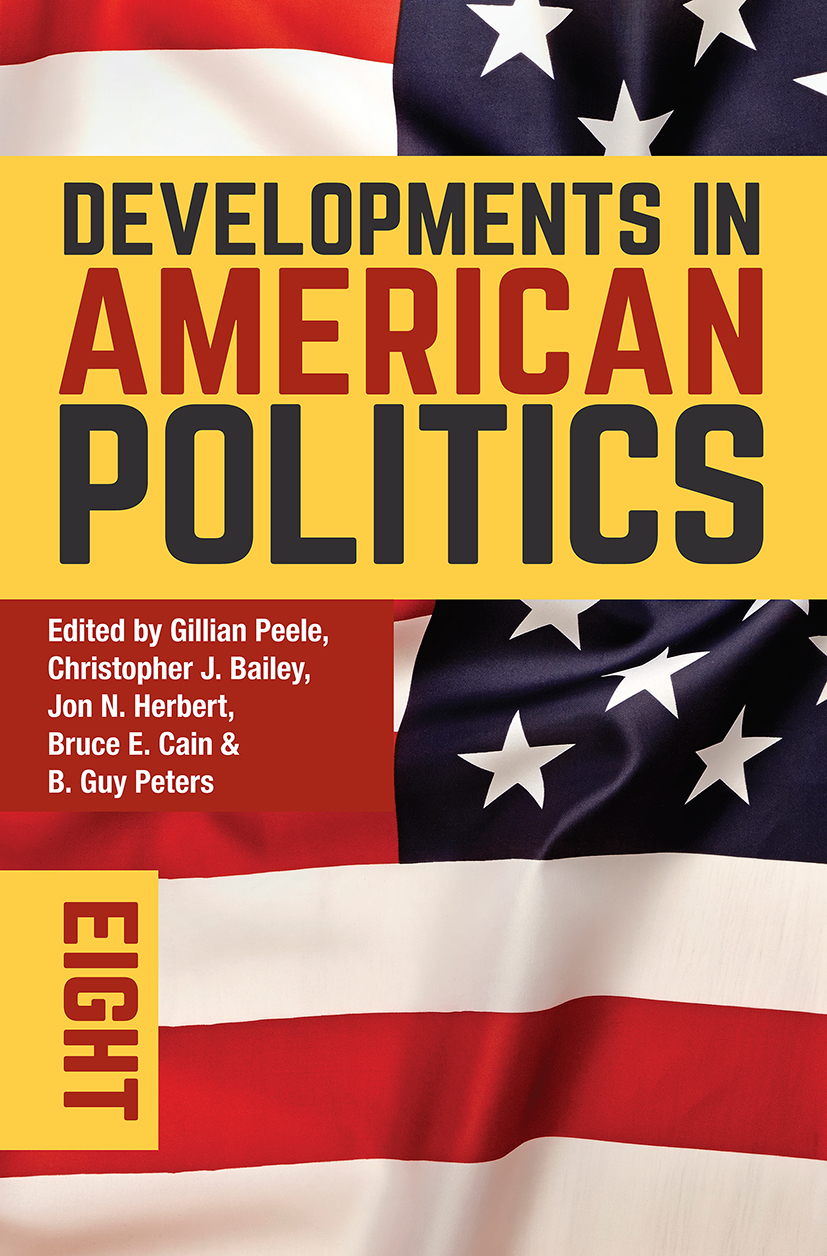
Developments in American Politics 8 Written by a team of leading experts of American politics, this text provides an authoritative and informed analysis of the latest issues, trends and developments. Fully up-to-date, the book takes full account of the political landscape that followed the 2012 elections and the policy dilemmas which face Obama's second administration. POLITICAL SCIENCE,American Government,General
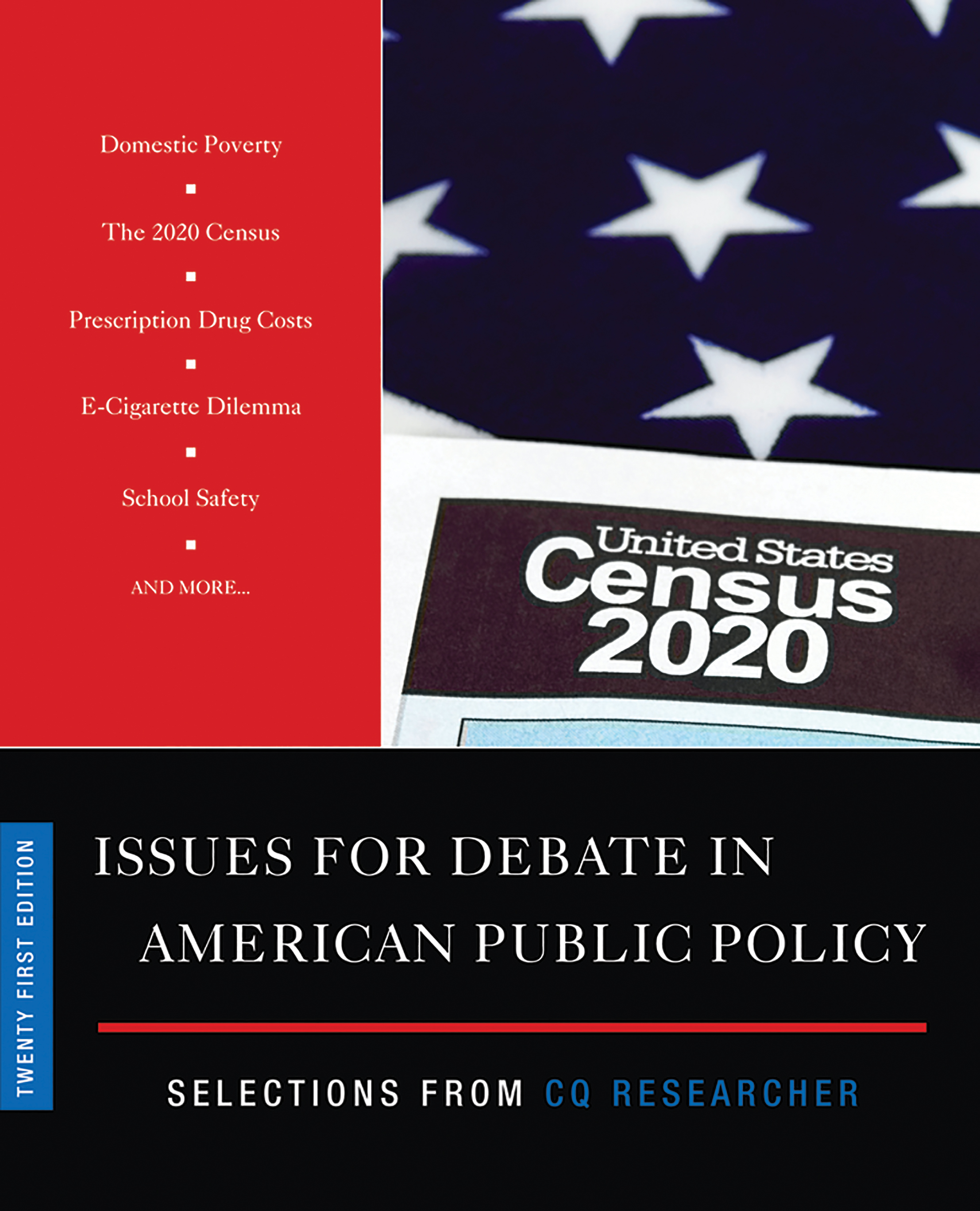
Issues for Debate in American Public Policy This collection of nonpartisan and thoroughly researched reports focuses on sixteen hot-button policy issues written by award-winning CQ Researcher journalists. Because it is an annual volume and comes together just months before publication, each report is as current as possible. And because it is CQ Researcher, the policy reports are expertly researched and written, showing all sides of an issue. Chapters follow a set organization, exploring three issue questions, then offering background, the current situation, and a look ahead, as well as featuring a yes-no debate box. All issues include a chronology, bibliography, photos, charts, and figures. POLITICAL SCIENCE,American Government,General

The Demagogue's Playbook A New York Times Book Review Editor's Pick What Happens to Democracy When a Demagogue Comes to Power? "It is hard to imagine understanding the Trump presidency and its significance without reading this book.†—Bob Bauer, Former Chief Counsel to President Barack Obama What—and who—is a demagogue? How did America’s Founders envision the presidency? What should a constitutional democracy look like—and how can it be fixed when it appears to be broken? Something is definitely wrong with Donald Trump’s presidency, but what exactly? The extraordinary negative reaction to Trump’s election—by conservative intellectuals, liberals, Democrats, and global leaders alike—goes beyond ordinary partisan and policy disagreements. It reflects genuine fear about the vitality of our constitutional system. The Founders, reaching back to classical precedents, feared that their experiment in mass self-government could produce a demagogue: a charismatic ruler who would gain and hold on to power by manipulating the public rather than by advancing the public good. President Trump, who has played to the mob and attacked institutions from the judiciary to the press, appears to embody these ideas. How can we move past his rhetoric and maintain faith in our great nation? In The Demagogue’s Playbook, acclaimed legal scholar Eric A. Posner offers a blueprint for how America can prevent the rise of another demagogue and protect the features of a democracy that help it thrive—and restore national greatness, for one and all. “Cuts through the hyperbole and hysteria that often distorts assessments of our republic, particularly at this time.†— Alan Taylor, winner of the 2014 Pulitzer Prize for History POLITICAL SCIENCE,American Government,General
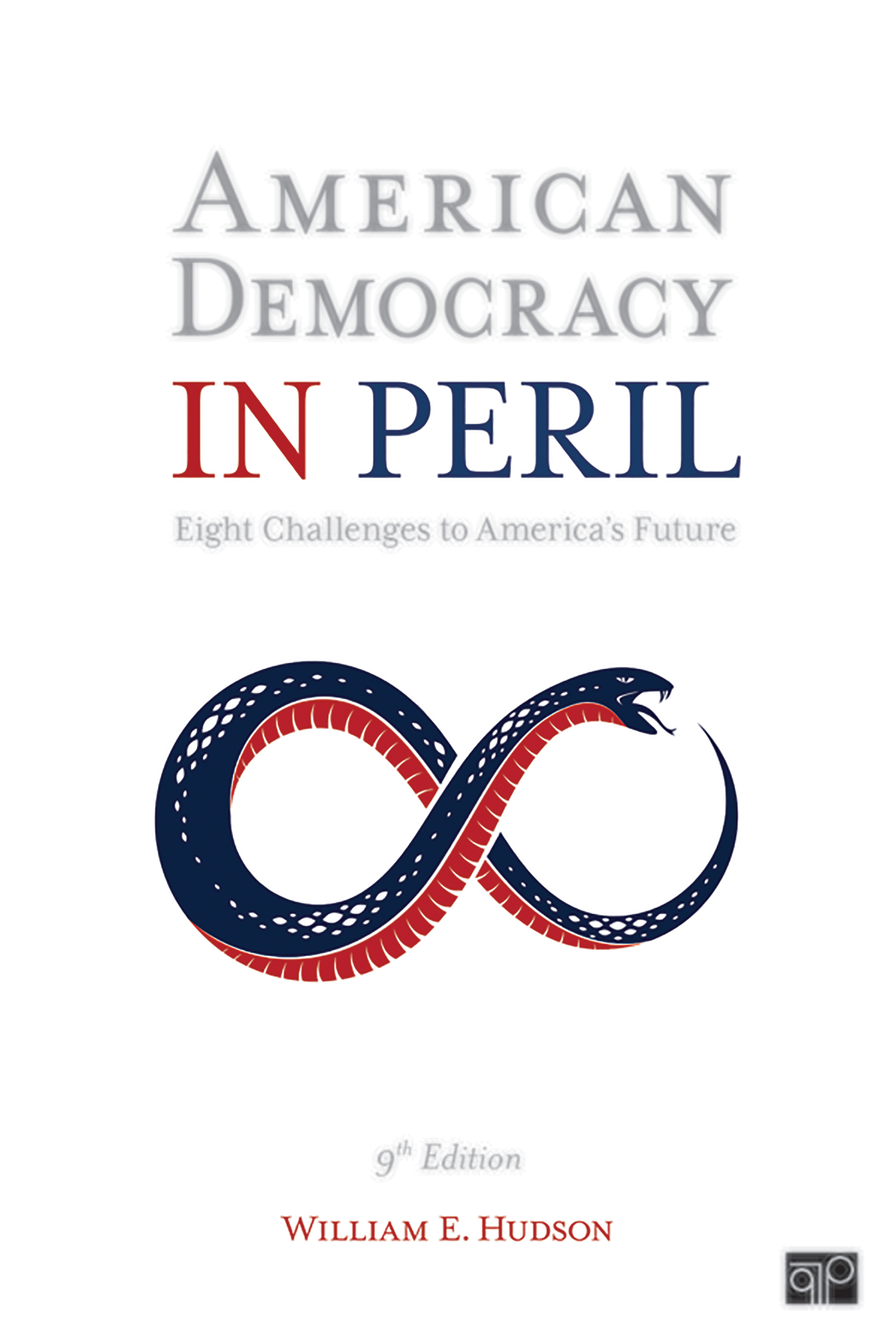
American Democracy in Peril American Democracy in Peril encapsulates the tumultuous state of American politics. By introducing the history of democratic theory in terms of four “models†of democracy, Hudson provides readers with a set of criteria against which to evaluate the challenges discussed later. This provocative book offers a structured yet critical examination of the American political system, designed to stimulate students to consider how the facts they learn about American politics relate to democratic ideals. This new edition incorporates the Trump Presidency and the polarization that has accompanied his leadership. POLITICAL SCIENCE,American Government,General
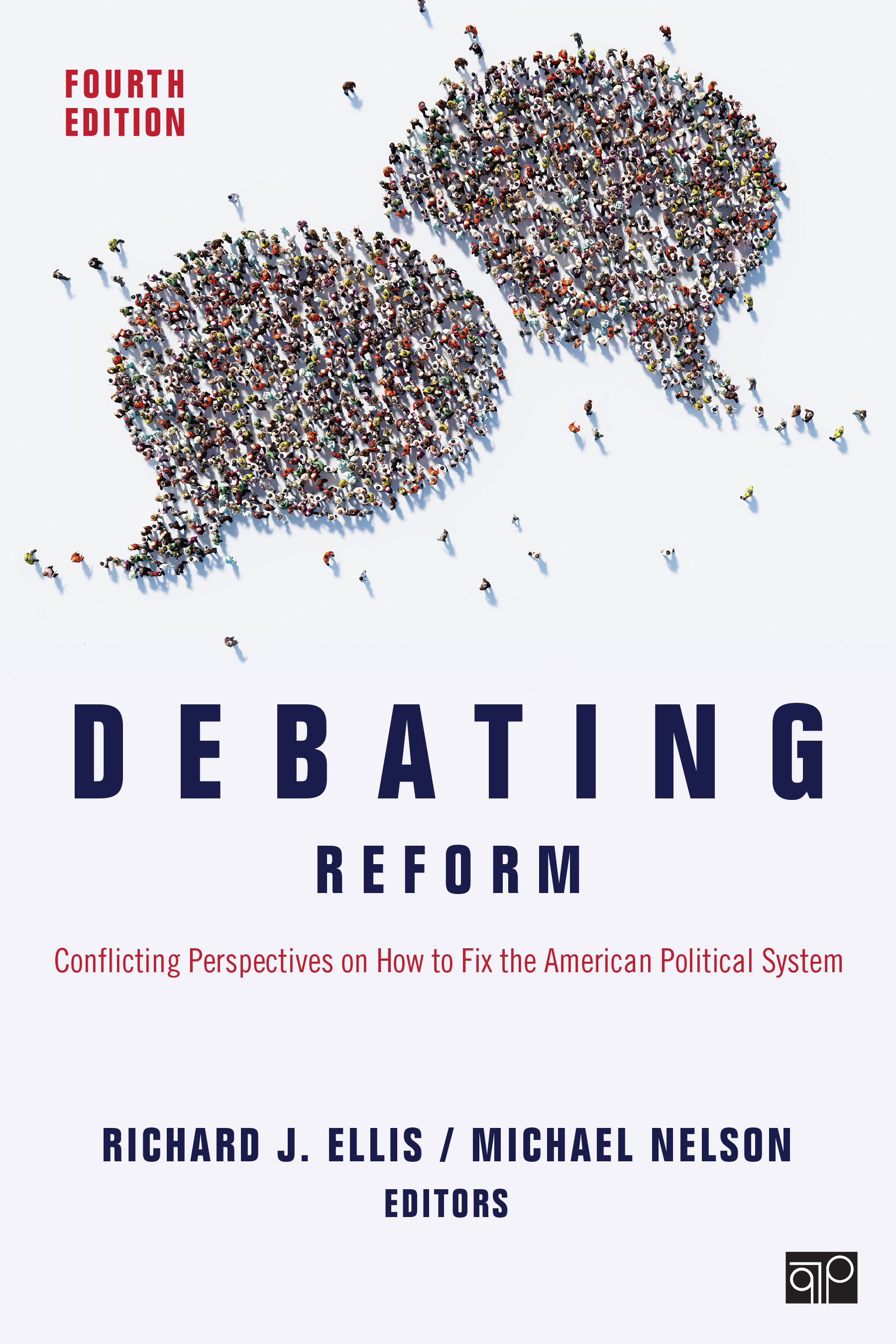
Debating Reform Getting students away from spouting opinions about highly-charged partisan issues, Debating Reform, Fourth Edition looks at key questions about reforming political institutions, with contributed pieces written by top scholars specifically for the volume. Each pro or con essay considers a concrete proposal for reforming the political system. By focusing on institutions, rather than liberal or conservative public policies, students tend to leave behind ideology and grapple with claims and evidence to draw their own conclusions and build their own arguments. Students will explore how institutions work in their American government text, but this reader helps them to understand how they can be made to work better. POLITICAL SCIENCE,American Government,General
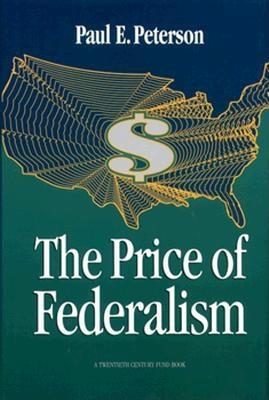
The Price of Federalism What is the price of federalism? Does it result in governmental interconnections that are too complex? Does it create overlapping responsibilities? Does it perpetuate social inequalities? Does it stifle economic growth? To answer these questions, Paul Peterson sets forth two theories of federalism: functional and legislative. Functional theory is optimistic. It says that each level of the federal system is well designed to carry out the tasks for which it is mainly responsible. State and local governments assume responsibility for their area's physical and social development; the national government cares for the needy and reduces economic inequities. Legislative theory, in contrast, is pessimistic: it says that national political leaders, responding to electoral pressures, misuse their power. They shift unpopular burdens to lower levels of government while spending national dollars on popular government programs for which they can claim credit. Both theories are used to explain different aspects of American federalism. Legislative theory explains why federal grants have never been used to equalize public services. Elected officials cannot easily justify to their constituents a vote to shift funds away from the geographic area they represent. The overall direction that American federalism has taken in recent years is better explained by functional theory. As the costs of transportation and communication have declined, labor and capital have become increasingly mobile, placing states and localities in greater competition with one another. State and local governments are responding to these changes by overlooking the needs of the poor, focusing instead on economic development. As a further consequence, older, big cities of the Rust Belt, inefficient in their operations and burdened by social responsibilities, are losing jobs and population to the suburban communities that surround them. Peterson recommends that the national government adopt p POLITICAL SCIENCE,American Government,General

Rise Up NOW A NATIONAL BESTSELLER “This man is a gift from God to the world. This book is a gift from Al Sharpton to us. Let’s appreciate them both.â€â€”Michael Eric Dyson Beginning with a foreword by Michael Eric Dyson and closing with Rev. Al Sharpton’s moving eulogy for George Floyd, Rise Up is a rousing call to action for our nation, drawing on lessons learned from Reverend Al Sharpton’s unique experience as a politician, television and radio host, and civil rights leader. Rise Up offers timeless lessons for anyone who’s stood at the crossroads of their personal or political life, weighing their choices of how to proceed. When the young Alfred Charles Sharpton told his mother he wanted to be a preacher, little did he know that his journey would also lead him to prominence as a politician, founder of the National Action Network, civil rights activist, and television and radio talk show host. His enduring ability and willingness to take on the political power structure makes him the preeminent voice for the modern era, a time unprecedented in its challenges. In Rise Up, Reverend Sharpton revisits the highlights of the Obama administration, the 2016 election and Trump’s subsequent hold on the GOP, and draws on his decades-long experience with other key players in politics and activism, including Shirley Chisholm, Hillary Clinton, Dr. Martin Luther King Jr. and more. The time has come to take a hard look at our collective failures and shortcomings and reclaim our core values in order to build a clear and just path forward for America. Our nation today stands at a crossroads—and change can’t wait. “Full of history, honesty, and valuable suggestions, Rise Up should be a staple in every home, school and library as an essential primer on civil and political rights in America.â€â€”Martin Luther King, III “If you want to learn how to use your voice to change a nation, you should study closely this man—and this book.†—Van Jones “My Bed-Stuy (do or die) brother has been at the forefront of our battles again and again. From way back in da way back to this present revolution the world is in now, Rev. has been about Black Lives Matter from the jump, also at a time when it was not the most popular or hip thing to be about. I look forward, standing next to him, to see, to witness this new energy, this new day that is about to be in these United States of America.â€â€”Spike Lee POLITICAL SCIENCE,American Government,General
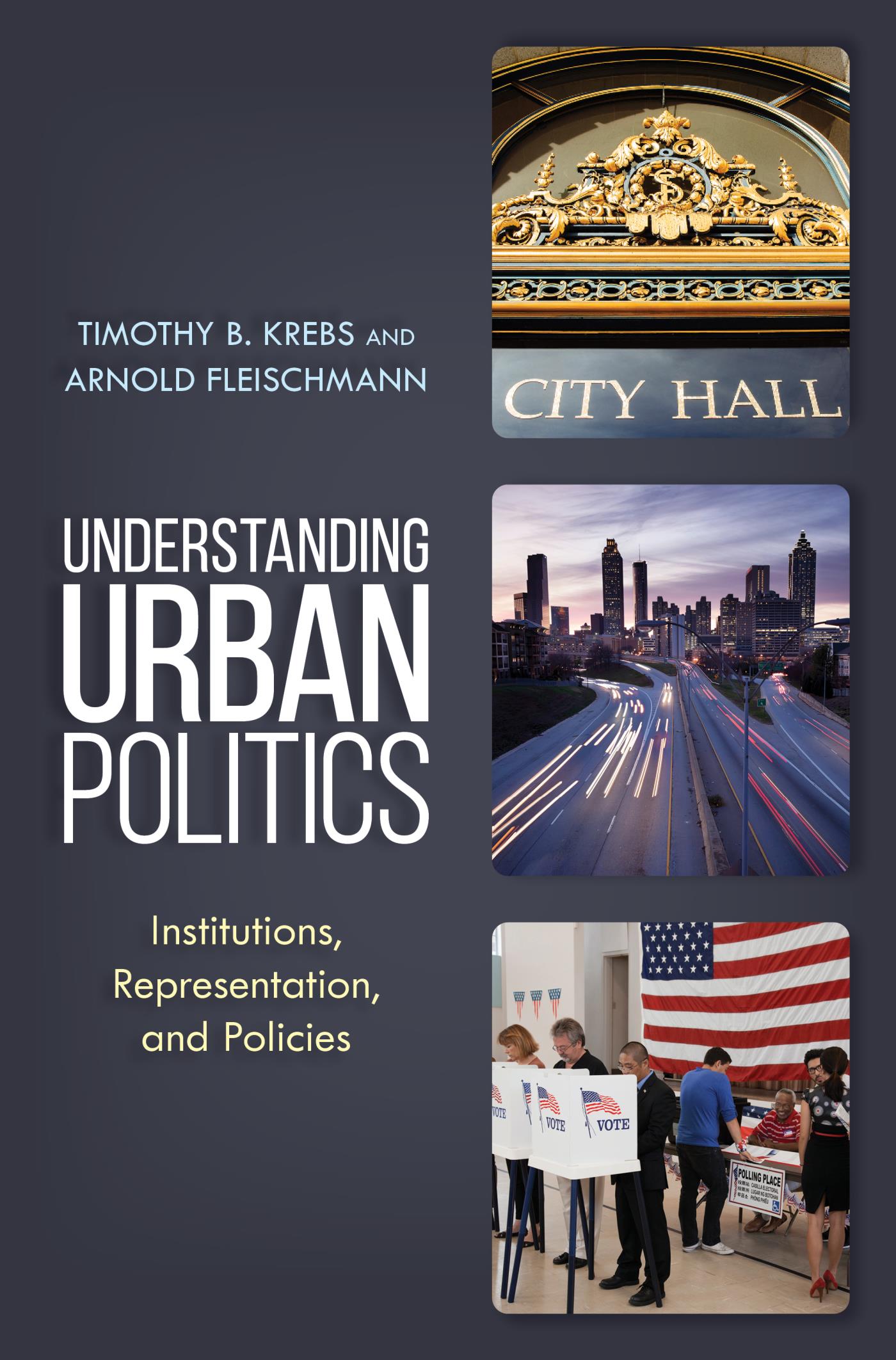
Understanding Urban Politics This is the first new urban politics text in several decades. The book uses the most recent research and other sources to explore how political institutions, participation and representation, and policy making have affected—and will continue to influence—the development, condition, and governance of urban America. POLITICAL SCIENCE,American Government,General
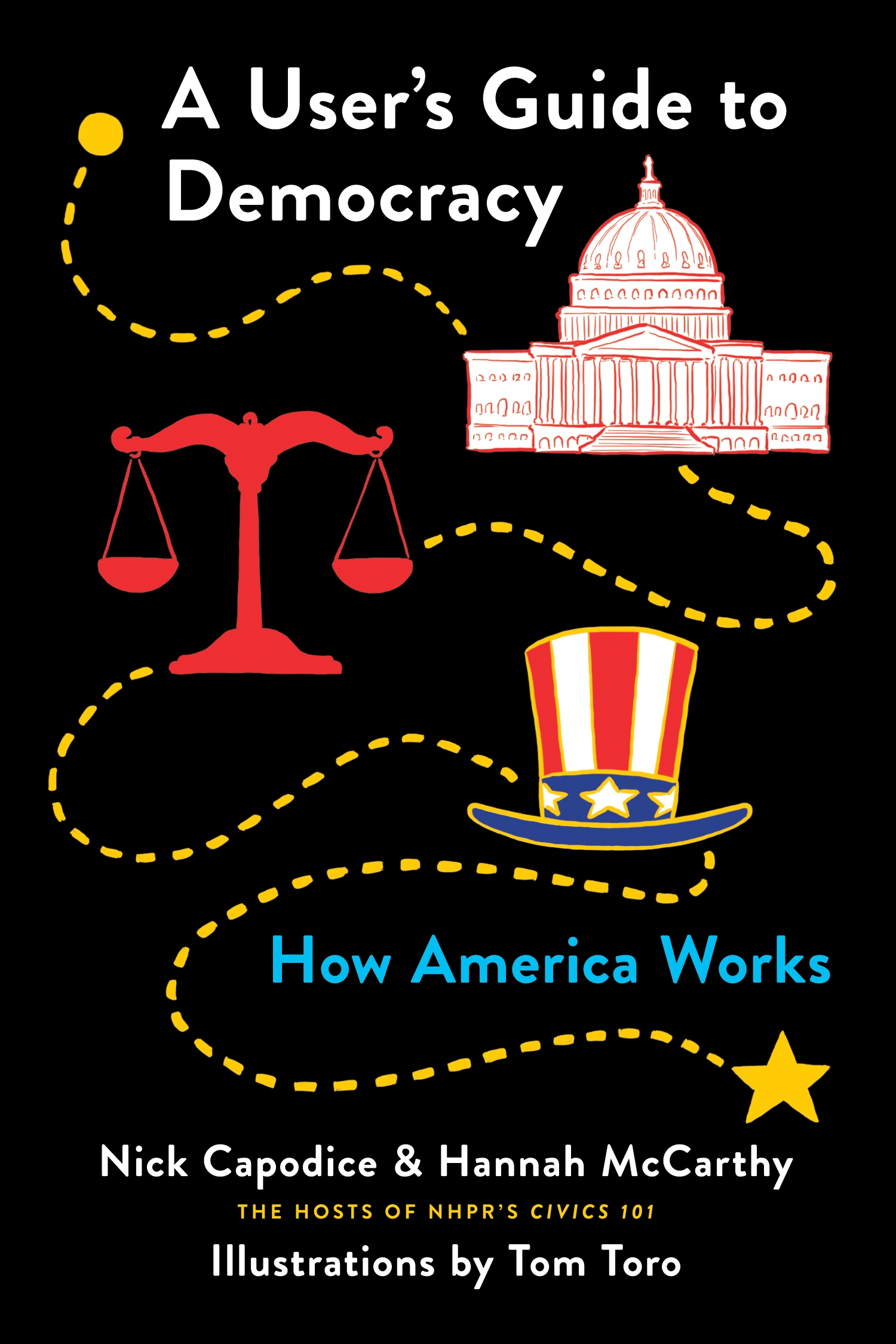
A User's Guide to Democracy From Nick Capodice & Hannah McCarthy, the hosts of New Hampshire Public Radio’s Civics 101, and New Yorker cartoonist Tom Toro, A User's Guide to Democracy is a lively crash course in everything you should know about how the US government works. Do you know what the Secretary of Defense does all day? Are you sure you know the difference between the House and the Senate? Have you been pretending you know what Federalism is for the last 20 years? Don’t worry--you’re not alone. The American government and its processes can be dizzyingly complex and obscure. Until now. Within this book are the keys to knowing what you’re talking about when you argue politics with the uncle you only see at Thanksgiving. It’s the book that sits on your desk for quick reference when the nightly news boggles your mind. This approachable and informative guide gives you the lowdown on everything from the three branches of government, to what you can actually do to make your vote count, to how our founding documents affect our daily lives. Now is the time to finally understand who does what, how they do it, and the best way to get them to listen to you. POLITICAL SCIENCE,American Government,General

Hell at the Gates The ultimate behind-the-scenes account of Ireland's biggest news story of recent years. POLITICAL SCIENCE,American Government,General

Poorer Richard's America For decades, Benjamin Franklin’s Poor Richard’s Almanack provided sage advice and commentary on eighteenth-century America. Now, a modern businessman reflectswriting as Benjamin Franklinon what America has become. Federal and personal debt are ballooning beyond sustainable levels. Our futures are being jeopardized. Partisan bickering and the entrenched powers of special interests have made it nearly impossible for a real leader to lead. Where is a good American to turn? How about to the man who wrote this timeless observation: A small leak will sink a great ship� Ben is back! With his signature intelligence and wit (not to mention a good sprinkling of aphorisms both old and new), Benjamin Franklin, through Tom Blair, moves from the national deficit to Wall Street, from health care to marital bliss. The result is electrifying. POLITICAL SCIENCE,American Government,General

Without a Country Many Americans believe service in the military to be a quintessential way to demonstrate patriotism. We expect those who serve to be treated with respect and dignity. However, as in so many aspects of our politics, the reality and our ideals diverge widely in our treatment of veterans. There is perhaps no starker example of this than the continued practice of deporting men and women who have served. J. Malcolm Garcia has travelled across the country and abroad to interview veterans who have been deported, as well as the families and friends they have left behind, giving the full scope of the tragedy to be found in this all too common practice. Without a Country analyzes the political climate that has led us here and takes a hard look at the toll deportation has taken on American vets and their communities. Deported veterans share in and reflect the diversity of America itself. The numerous compounding injustices meted out to them reflect many of the still unresolved contradictions of our nation and its ideals. But this story, in all its grit and complexity, really boils down to an old, simple question: Who is a real American? POLITICAL SCIENCE,American Government,General
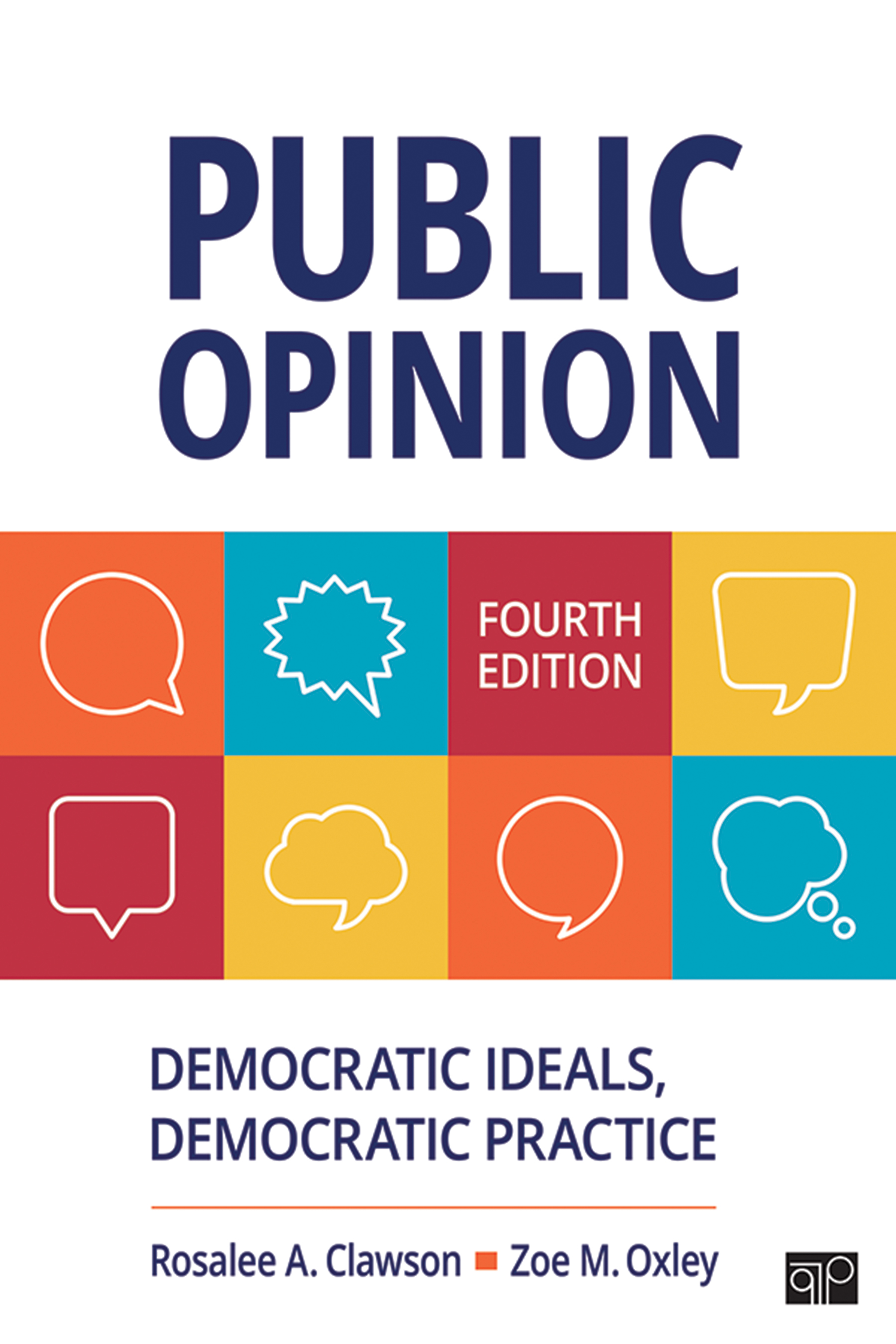
Public Opinion Clawson and Oxley link the enduring normative questions of democratic theory to existing empirical research on public opinion. Organized around a series of questions—In a democratic society, what should be the relationship between citizens and their government? Are citizens’ opinions pliable? Are they knowledgeable, attentive, and informed?—the text explores the tension between ideals and their practice. Each chapter focuses on exemplary studies, explaining not only the conclusion of the research, but how it was conducted, so students gain a richer understanding of the research process and see methods applied in context. POLITICAL SCIENCE,American Government,General
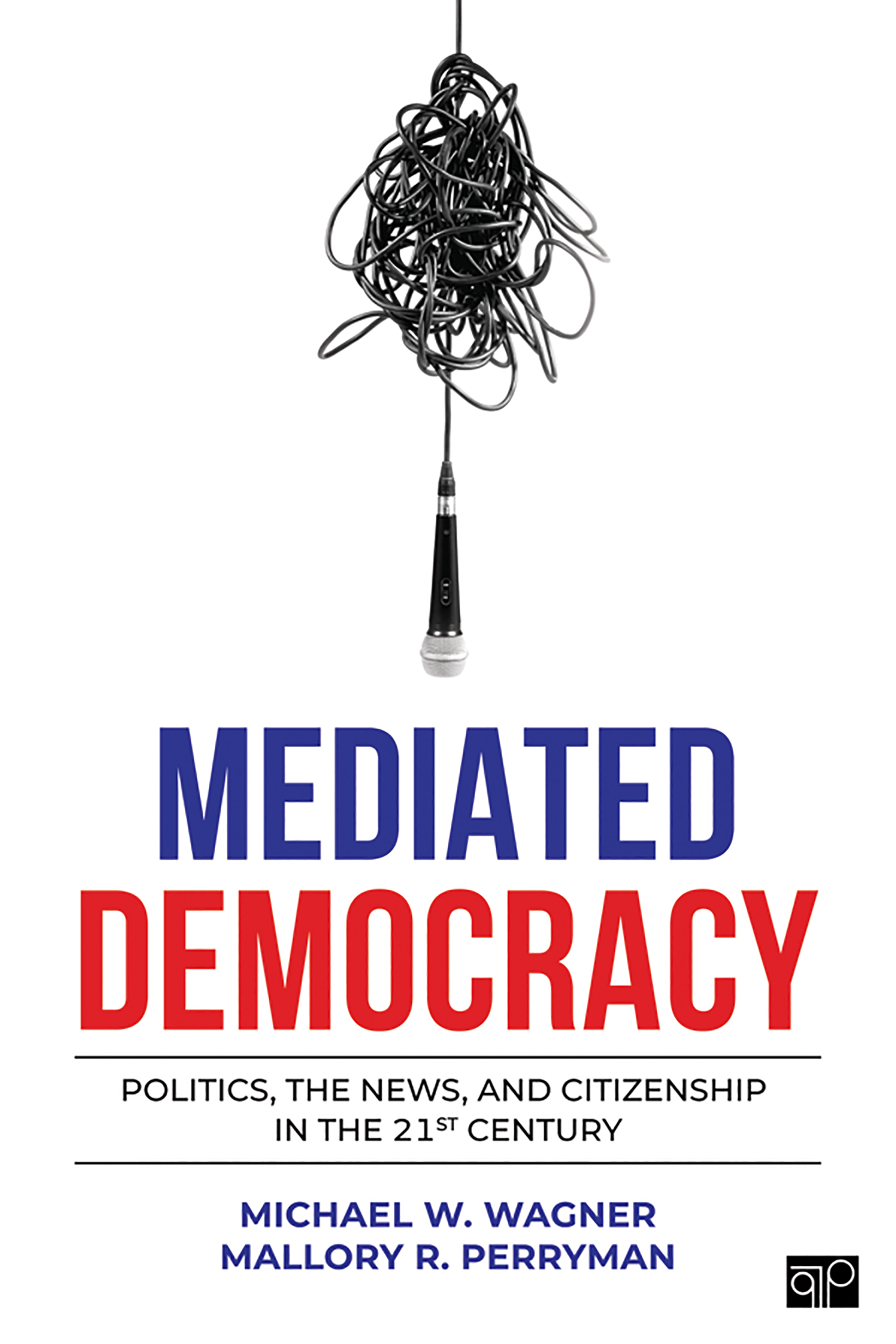
Mediated Democracy Mediated Democracy: Politics, the News, and Citizenship in the 21st Century takes a contemporary, communications-oriented perspective on the central questions pertaining to the health of democracies and relationships between citizens, journalists, and political elites. The approach marries clear syntheses of cutting-edge research with practical advice explaining why the insights of scholarship affects students’ lives. With active, engaging writing, the text will thoroughly explain why things are the way they are, how they got that way, and how students can use the insights of political communication research to do something about it as citizens. POLITICAL SCIENCE,American Government,General

Issues for Debate in American Public Policy Written by award-winning CQ Researcher journalists, this annual collection of nonpartisan and thoroughly researched reports focuses on 16 hot-button policy issues. The Twenty-Second Edition of Issues for Debate in American Public Policy promotes in-depth discussion, facilitates further research, and helps readers formulate their own positions on crucial policy issues. And because it is CQ Researcher, the policy reports are expertly researched and written, showing readers all sides of an issue. POLITICAL SCIENCE,American Government,General

Original Politics To recreate a whole and sacred America, it is important to piece together the forgotten fragments of history that are currently keeping the country divided. Just as a traditional Native American potter begins a new pot with shards of old pots—honoring the ancestors, bringing the energies of the past into the present—Original Politics re-constellates the nation as a whole out of the seemingly disparate shards from our origins. The most significant forgotten piece is the profound effect Native America had on the founding values of this nation. Original Politics convincingly demonstrates how the best aspects of the founding vision of America were inspired, or directly appropriated, from living, Native American cultures: concepts such as natural rights, liberty, and egalitarian justice. Further, Parry traces the influence of Native America not only on the founding fathers, but on the ‘founding mothers' of the 19th century women's movement; as well as the 19th century abolitionist and modern ecological movements. Native America has inspired what Parry sees as the sacred purpose of the nation: bringing all the world's peoples together on one soil in a harmonious cultural mosaic of unity in diversity. While there have been periodic setbacks (devolution) in our nation's history, including today, these only serve as catalysts reigniting our sacred purpose. America is creating a new melting pot, and like the original vision, it will be a creation from the many into the one—only this time it must not leave anyone out. This includes the natural world. Original Politics is ultimately about respecting all forms of life and all forms of political expression as different aspects of one whole. It is a reclamation project that brings people, land, and nation together as one. The overall effect of the book is profoundly healing. POLITICAL SCIENCE,American Government,General

A Case for the American People The Democrats’ special impeachment counsel on the House Judiciary Committee lays out President Trump’s shocking pattern of betrayals, lies, and high crimes, arguing articles of impeachment to the ultimate judges: the American people. In his behind-the-scenes account of the attempts to bring the president to justice—from filing the very first legal actions against him, through the Mueller report, to the turbulent impeachment and trial, to the president’s ongoing wrongdoing today—Norman Eisen, at the forefront of the battle since the day of Trump’s inauguration, pulls back the curtain on the process. He reveals ten proposed articles of impeachment, not just the two that were publicly tried, all of which he had a hand in drafting. He then guides us through Trump’s lifelong instincts that have dictated his presidency: a cycle of abuse, corruption, and relentless obstruction of the truth. Since taking the oath of office, Donald Trump has been on a spree of high crimes and misdemeanors, using the awesome power of the presidency for his own personal gain, at the expense of the American people. He has inflamed our divisions for his electoral benefit, with flagrant disregard for the Constitution that makes us America. Each step of the way, he has lied incessantly, including to cover up his crimes. And yet he remains in the country’s highest office. Congress, federal and state prosecutors, and courts have worked to hold the president accountable for his myriad offenses—with some surprising successes and devastating failures. Eisen, who served as special counsel to the House Judiciary Committee for Trump’s impeachment and trial, presents the case against Trump anew. Eisen’s gripping narrative and rousing closing argument—at turns revelatory, insightful, and enraging—will inspire our nation of judges. History has proven that this president’s nefarious behavior will continue, no matter the crisis. But, as Eisen’s candid retelling affirms, there is an ultimate constitutional power that transcends the president’s, a power that can and must defeat him if our nation is to survive. The verdict of the American people remains in the balance. It is time for us to act. POLITICAL SCIENCE,American Government,General

Presidents and Political Scandal This book explores presidential power through an analysis of the ways that U.S. presidents attempt to manage scandals. While presidents routinely stonewall to block or limit investigations into their alleged transgressions or, in some cases, cooperate with investigators, this book proposes the existence of a third way of responding to scandals—a “backfire†or the creation of a counter-scandal to try to extinguish the original scandal. The existence of possible backfires is surveyed through case studies of the major scandals that impacted the Nixon, Reagan, Clinton, and Trump administrations. The development of this form of scandal response has meaningful implications concerning the growth of presidential power and its impacts on the functioning of the U.S. political system and the quality of American democracy. Changes in partisanship, the media environment, and the public’s view of the presidency and government are topics covered in the book’s explanation of the trends in scandal responses. POLITICAL SCIENCE,American Government,General

Ordinary Injustice "A groundbreaking book . . . revealing the systemic, everyday problems in our courts that must be addressed if justice is truly to be served."—Doris Kearns Goodwin Attorney and journalist Amy Bach spent eight years investigating the widespread courtroom failures that each day upend lives across America. What she found was an assembly-line approach to justice: a system that rewards mediocre advocacy, bypasses due process, and shortchanges both defendants and victims to keep the court calendar moving. Here is the public defender who pleads most of his clients guilty with scant knowledge about their circumstances; the judge who sets outrageous bail for negligible crimes; the prosecutor who habitually declines to pursue significant cases; the court that works together to achieve a wrongful conviction. Going beyond the usual explanations of bad apples and meager funding, Ordinary Injustice reveals a clubby legal culture of compromise, and shows the tragic consequences that result when communities mistake the rules that lawyers play by for the rule of law. It is time, Bach argues, to institute a new method of checks and balances that will make injustice visible—the first and necessary step to reform. POLITICAL SCIENCE,American Government,Judicial Branch

The Brethren The Brethren is the first detailed behind-the-scenes account of the Supreme Court in action. Bob Woodward and Scott Armstrong have pierced its secrecy to give us an unprecedented view of the Chief and Associate Justices—maneuvering, arguing, politicking, compromising, and making decisions that affect every major area of American life. POLITICAL SCIENCE,American Government,Judicial Branch
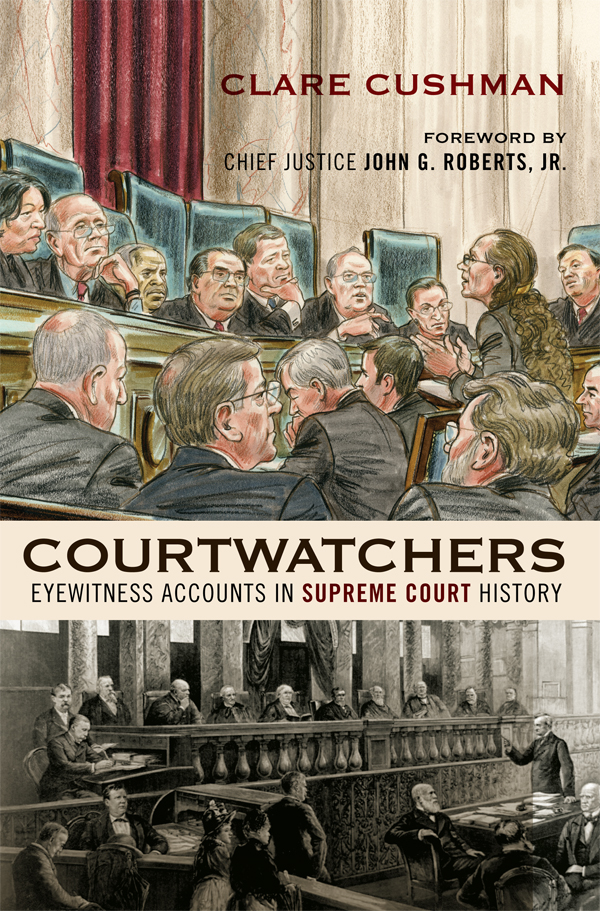
Courtwatchers In the first Supreme Court history told primarily through eyewitness accounts from Court insiders, Clare Cushman provides readers with a behind-the-scenes look at the people, practices, and traditions that have shaped an American institution for more than 200 years. This entertaining and enlightening tour of the Supreme Court’s colorful personalities and inner workings will be of interest to all readers of American political and legal history. POLITICAL SCIENCE,American Government,Judicial Branch

Confirmation Wars In Confirmation Wars, Benjamin Wittes examines the degradation of the judicial nominations process over the past fifty years. Drawing on years of reporting on judicial nominations, including numerous interviews with nominees and sitting judges, he explains how the process has changed and how these changes threaten the independence of the courts. Getting beyond the partisan blame game that dominates most discussion of nominations, he argues that the process has changed as an institutional response by Congress to modern judicial power and urges basic reforms to better insulate the judiciary from the nastiness of contemporary politics. POLITICAL SCIENCE,American Government,Judicial Branch
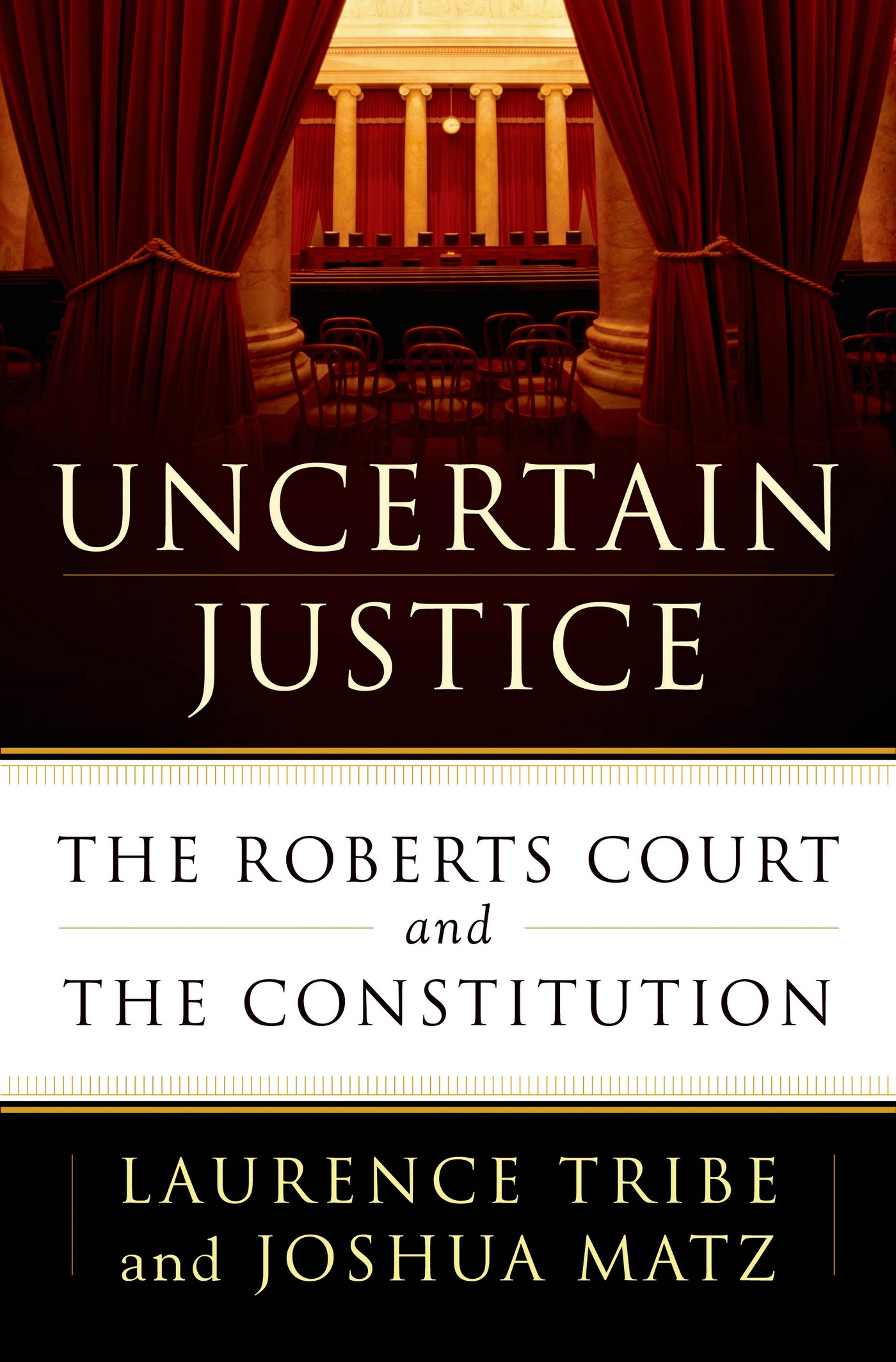
Uncertain Justice With the Supreme Court more influential than ever, this eye-opening book tells the story of how the Roberts Court is shaking the foundation of our nation's laws From Citizens United to its momentous rulings regarding Obamacare and gay marriage, the Supreme Court under Chief Justice John Roberts has profoundly affected American life. Yet the court remains a mysterious institution, and the motivations of the nine men and women who serve for life are often obscure. Now, in Uncertain Justice, Laurence Tribe and Joshua Matz show the surprising extent to which the Roberts Court is revising the meaning of our Constitution. This essential book arrives at a make-or-break moment for the nation and the court. Political gridlock, cultural change, and technological progress mean that the court's decisions on key topics—including free speech, privacy, voting rights, and presidential power—could be uniquely durable. Acutely aware of their opportunity, the justices are rewriting critical aspects of constitutional law and redrawing the ground rules of American government. Tribe—one of the country's leading constitutional lawyers—and Matz dig deeply into the court's recent rulings, stepping beyond tired debates over judicial "activism" to draw out hidden meanings and silent battles. The undercurrents they reveal suggest a strikingly different vision for the future of our country, one that is sure to be hotly debated.Filled with original insights and compelling human stories, Uncertain Justice illuminates the most colorful story of all—how the Supreme Court and the Constitution frame the way we live. POLITICAL SCIENCE,American Government,Judicial Branch

The Conservative Revolution of Antonin Scalia This collection is a comprehensive and thorough assessment of the impact and legacy that Justice Antonin Scalia had on the Supreme Court. Chapters are written by leading legal and political science scholars of the Supreme Court and examine the lasting legacy of one of the most controversial Supreme Court Justices in American history. POLITICAL SCIENCE,American Government,Judicial Branch

Against the Death Penalty A landmark dissenting opinion arguing against the death penalty Does the death penalty violate the Constitution? In Against the Death Penalty, Justice Stephen G. Breyer argues that it does: that it is carried out unfairly and inconsistently, and thus violates the ban on "cruel and unusual punishments" specified by the Eighth Amendment to the Constitution. "Today’s administration of the death penalty," Breyer writes, "involves three fundamental constitutional defects: (1) serious unreliability, (2) arbitrariness in application, and (3) unconscionably long delays that undermine the death penalty’s penological purpose. Perhaps as a result, (4) most places within the United States have abandoned its use." This volume contains Breyer's dissent in the case of Glossip v. Gross, which involved an unsuccessful challenge to Oklahoma's use of a lethal-injection drug because it might cause severe pain. Justice Breyer's legal citations have been edited to make them understandable to a general audience, but the text retains the full force of his powerful argument that the time has come for the Supreme Court to revisit the constitutionality of the death penalty. Breyer was joined in his dissent from the bench by Justice Ruth Bader Ginsburg. Their passionate argument has been cited by many legal experts including fellow Justice Antonin Scalia as signaling an eventual Court ruling striking down the death penalty. A similar dissent in 1963 by Breyer's mentor, Justice Arthur J. Goldberg, helped set the stage for a later ruling, imposing what turned out to be a four-year moratorium on executions. POLITICAL SCIENCE,American Government,Judicial Branch
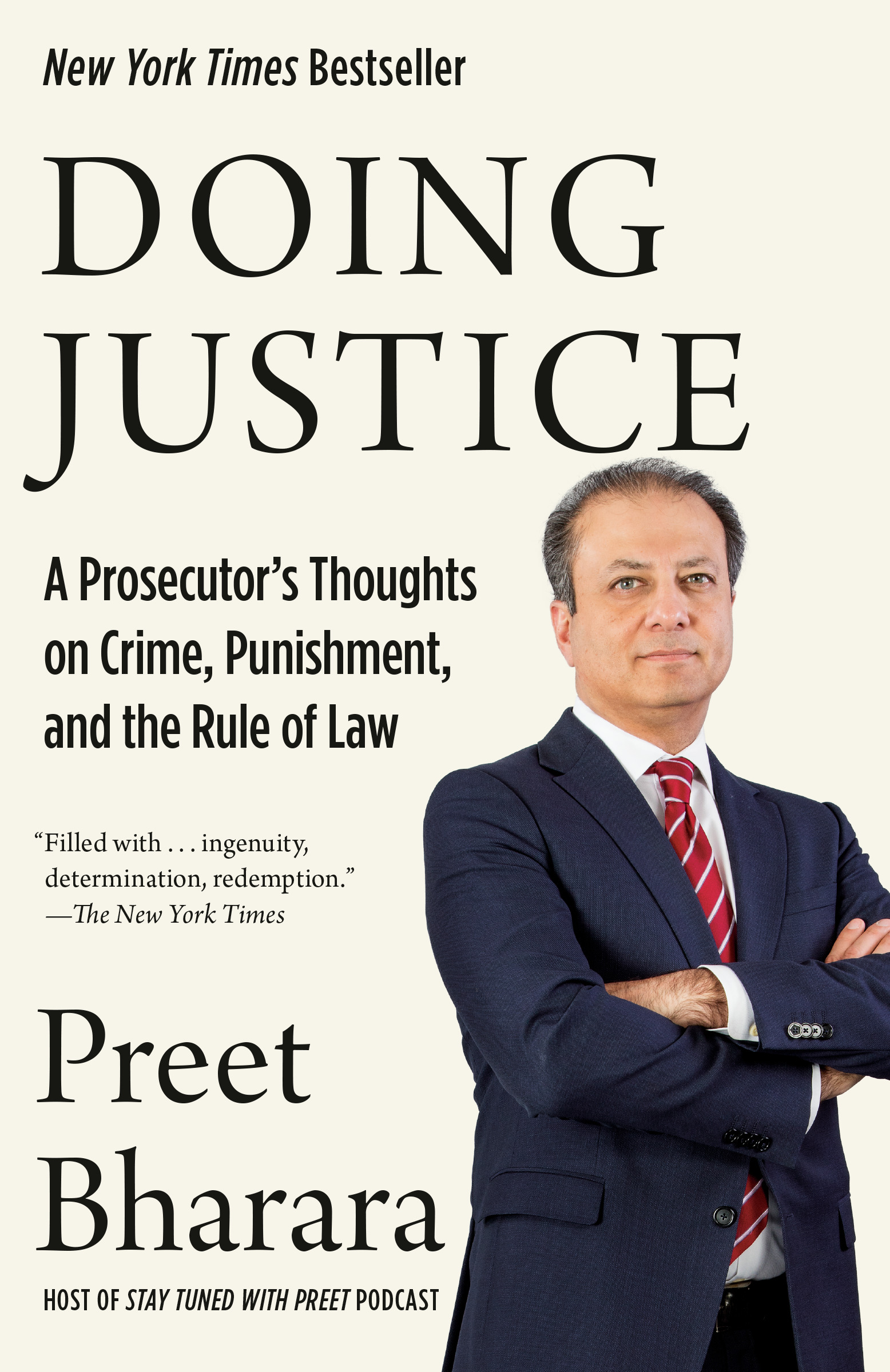
Doing Justice By the one-time federal prosecutor for the Southern District of New York, an important overview of the way our justice system works, and why the rule of law is essential to our society. Using case histories, personal experiences and his own inviting writing and teaching style, Preet Bharara shows the thought process we need to best achieve truth and justice in our daily lives and within our society. Preet Bharara has spent much of his life examining our legal system, pushing to make it better, and prosecuting those looking to subvert it. Bharara believes in our system and knows it must be protected, but to do so, we must also acknowledge and allow for flaws in the system and in human nature. The book is divided into four sections: Inquiry, Accusation, Judgment and Punishment. He shows why each step of this process is crucial to the legal system, but he also shows how we all need to think about each stage of the process to achieve truth and justice in our daily lives. Bharara uses anecdotes and case histories from his legal career--the successes as well as the failures--to illustrate the realities of the legal system, and the consequences of taking action (and in some cases, not taking action, which can be just as essential when trying to achieve a just result). Much of what Bharara discusses is inspiring--it gives us hope that rational and objective fact-based thinking, combined with compassion, can truly lead us on a path toward truth and justice. Some of what he writes about will be controversial and cause much discussion. Ultimately, it is a thought-provoking, entertaining book about the need to find the humanity in our legal system--and in our society. POLITICAL SCIENCE,American Government,Judicial Branch
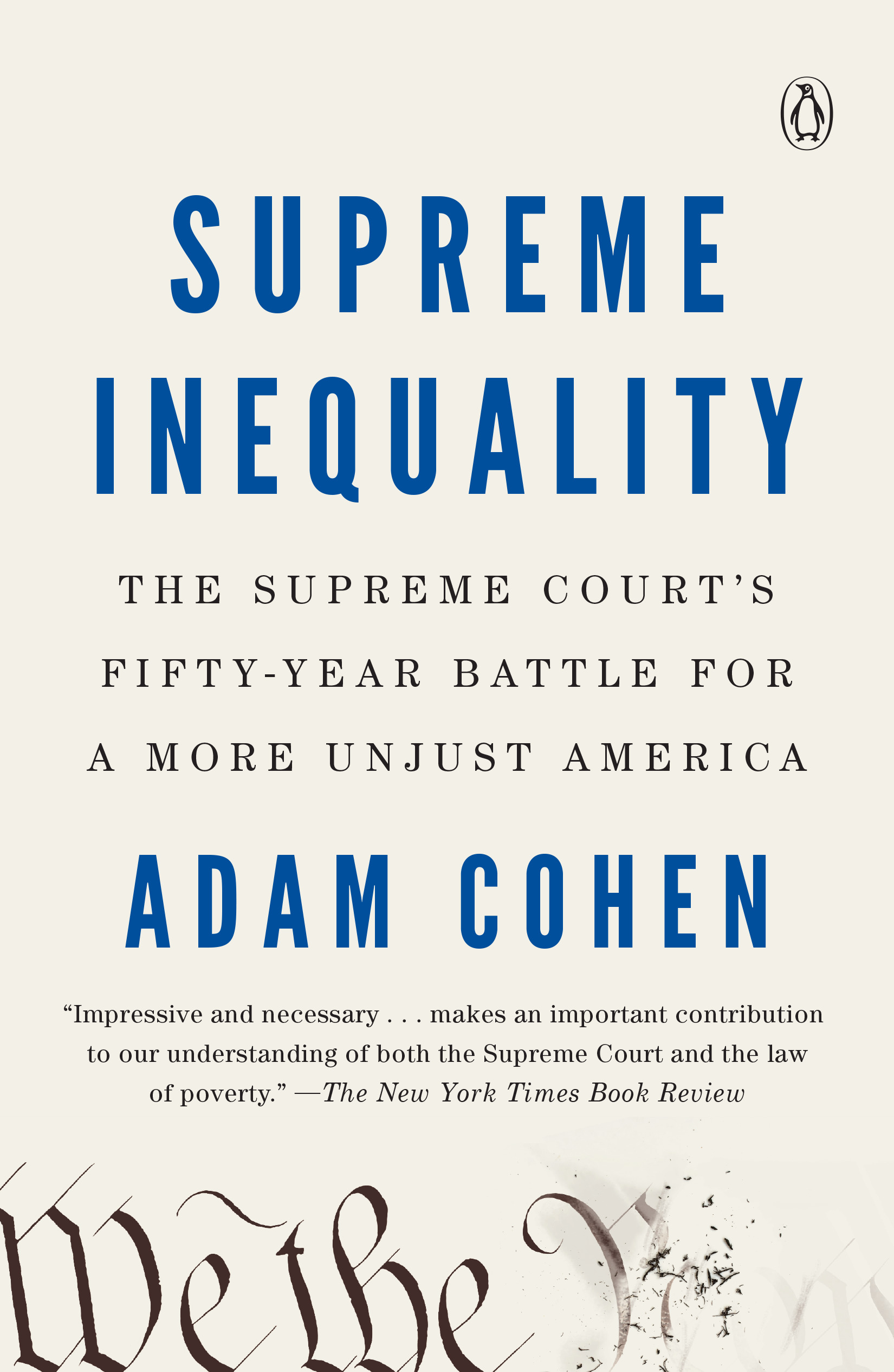
Supreme Inequality A New York Times "20 Books We're Watching For in 2020" pick From New York Times bestselling author Adam Cohen, a revelatory examination of the conservative direction of the Supreme Court over the last fifty years since the Nixon administration In 1969, newly elected president Richard Nixon launched an assault on the Supreme Court. He appointed four conservative justices in just three years, dismantling its previous liberal majority and setting it on a rightward course that continues to today. Before this drastic upheaval, the Court, led by Chief Justice Earl Warren, had been a powerful force for equality and inclusion, expanding the rights of the poor and racial minorities. Its rulings integrated schools across the South, established the Miranda warning for suspects in police custody, and recognized the principle of one person, one vote. But when Warren retired, Nixon used his four nominations to put a stop to that liberal agenda, and turn the Court into a force for his own views about what kind of nation America should be. In Supreme Inequality, bestselling author Adam Cohen surveys the most significant Supreme Court rulings since the Nixon era and exposes how rarely the Court has veered away from its agenda of promoting inequality. Contrary to what Americans like to believe, the Court does little to protect the rights of the poor and disadvantaged; in fact, it has not been on their side for fifty years. Many of the greatest successes of the Warren Court, in areas such as school desegregation, voting rights, and protecting workers, have been abandoned in favor of rulings that protect corporations and privileged Americans, who tend to be white, wealthy, and powerful. As the nation comes to grips with two new Trump-appointed justices, Cohen proves beyond doubt that the modern Court has been one of the leading forces behind the nation's soaring level of economic inequality, and that an institution revered as a source of fairness has been systematically making America less fair. A triumph of American legal, political, and social history, Supreme Inequality holds to account the highest court in the land, and shows how much damage it has done to America's ideals of equality, democracy, and justice for all. POLITICAL SCIENCE,American Government,Judicial Branch

Constitutional Law for a Changing America Capturing the authors’ excitement for constitutional law, this updated Tenth Edition of Constitutional Law for a Changing America shows you how judicial decisions are influenced by political factors—from lawyers and interest groups, to the shifting sentiments of public opinion, to the ideological and behavioral inclinations of the justices. Authors Lee Epstein and Thomas G. Walker show how these dynamics shape the development of constitutional doctrine. Known for fastidious revising and streamlining, the authors incorporate the latest scholarship in the fields of both political science and legal studies and offer solid analysis of both classic and contemporary landmark cases, including key opinions handed down through the 2017 session. Filled with additional supporting material—photographs of the litigants, sidebars comparing the United States with other nations, and “Aftermath†boxes that tell the stories of the parties' lives after the Supreme Court has acted—the text helps you develop a thorough understanding of the way the U.S. Constitution protects civil rights and liberties. POLITICAL SCIENCE,American Government,Judicial Branch

The Supreme Court Connecting recent events to their effects on the courts, policy, and society, the Thirteenth Edition of The Supreme Court provides a brief yet comprehensive introduction to the U.S. Supreme Court. In successive chapters, the book examines major aspects of the Court, including the selection, backgrounds, and departures of justices; the creation of the Court's agenda; the decision-making process and the factors that shape the Court's decisions; the substance of the Court's policies; and the Court's impact on government and American society. Delving deeply into personalities and procedures, author Lawrence Baum provides a balanced explanation of the Court’s actions and the behavior of its justices as he reveals its complexity, reach, and influence. Updated with the most recent data displayed in a lively photo program, the new edition of this bestseller is one of the most engaging books on this subject available. POLITICAL SCIENCE,American Government,Judicial Branch

Judicial Process in America Known for shedding light on the link between the courts, public policy, and the political environment, Judicial Process in America offers you a clear but comprehensive overview of today’s American judiciary. Considering the courts from every level, the authors thoroughly cover judges, lawyers, litigants, and the variables at play in judicial decision-making. The highly anticipated Eleventh Edition offers updated coverage of recent Supreme Court rulings, including same-sex marriage and health care subsidies; the effect of three women justices on the Court's patterns of decision; and the policy-making role of state tribunals as they consider an increasing number of state programs and policies. POLITICAL SCIENCE,American Government,Judicial Branch

Constitutional Law for a Changing America A host of political factors—both internal and external—influence the Court’s decisions and shape the development of constitutional law. Among the more significant forces at work are the ways lawyers and interest groups frame legal disputes, the ideological and behavioral propensities of the justices, the politics of judicial selection, public opinion, and the positions that elected officials take, to name just a few. Combining lessons of the legal model with the influences of the political process, Constitutional Law for a Changing America shows how these dynamics shape the development of constitutional doctrine. The Tenth Edition offers rigorous, comprehensive content in a student-friendly manner. With meticulous revising and updating throughout, best-selling authors Lee Epstein and Thomas G. Walker streamline material while accounting for new scholarship and recent landmark cases—including key opinions handed down through the 2018 judicial session. Well-loved features keep students engaged by offering a clear delineation between commentary and opinion excerpts, a “Facts†and “Arguments†section before every case, a superb photo program, “Aftermath†and “Global Perspective†boxes, and a wealth of tables, figures, and maps. Students will walk away with an understanding that Supreme Court cases involve real people engaged in real disputes and are not merely legal names and citations. POLITICAL SCIENCE,American Government,Judicial Branch

One Vote Away ** WALL STREET JOURNAL BESTSELLER ** USA TODAY BESTSELLER ** PUBLISHER'S WEEKLY BESTSELLER ** NEW YORK TIMES BESTSELLER ** AMAZON BESTSELLER ** With Justice Ruth Bader Ginsburg’s sudden passing, control of the Supreme Court—and with it the fate of the Constitution—has become the deciding issue for many voters in the 2020 presidential election. And the stakes could not be higher. With a simple majority on the Supreme Court, the left will have the power to curtail or even abolish the freedoms that have made our country a beacon to the world. We are one vote away from losing the Republic that the Founders handed down to us. Our most precious constitutional rights hang by a thread. Senator Ted Cruz has spent his entire career on the front line of the war to protect our constitutional rights. And as a Supreme Court clerk, solicitor general of Texas, and private litigator, he played a key role in some of the most important legal cases of the past two decades. In One Vote Away, you will discover how often the high court decisions that affect your life have been decided by just one vote. One vote preserves your right to speak freely, to bear arms, and to exercise your faith. One vote will determine whether your children enjoy their full inheritance as American citizens. God may endow us with “certain unalienable rights,†but whether we enjoy them depends on nine judges—the “priests of the robe†who have the last say in our system of government. Drawing back the curtain of their temple, Senator Cruz reveals the struggles, arguments, and strife that have shaped the fate of those rights. No one who reads One Vote Away can ever again take a single seat on the Supreme Court for granted. POLITICAL SCIENCE,American Government,Judicial Branch

The Campaign to Impeach Justice William O. Douglas A timely and richly detailed history exploring fascinating questions of judicial ethics, impeachment, and racial politics. POLITICAL SCIENCE,American Government,Judicial Branch
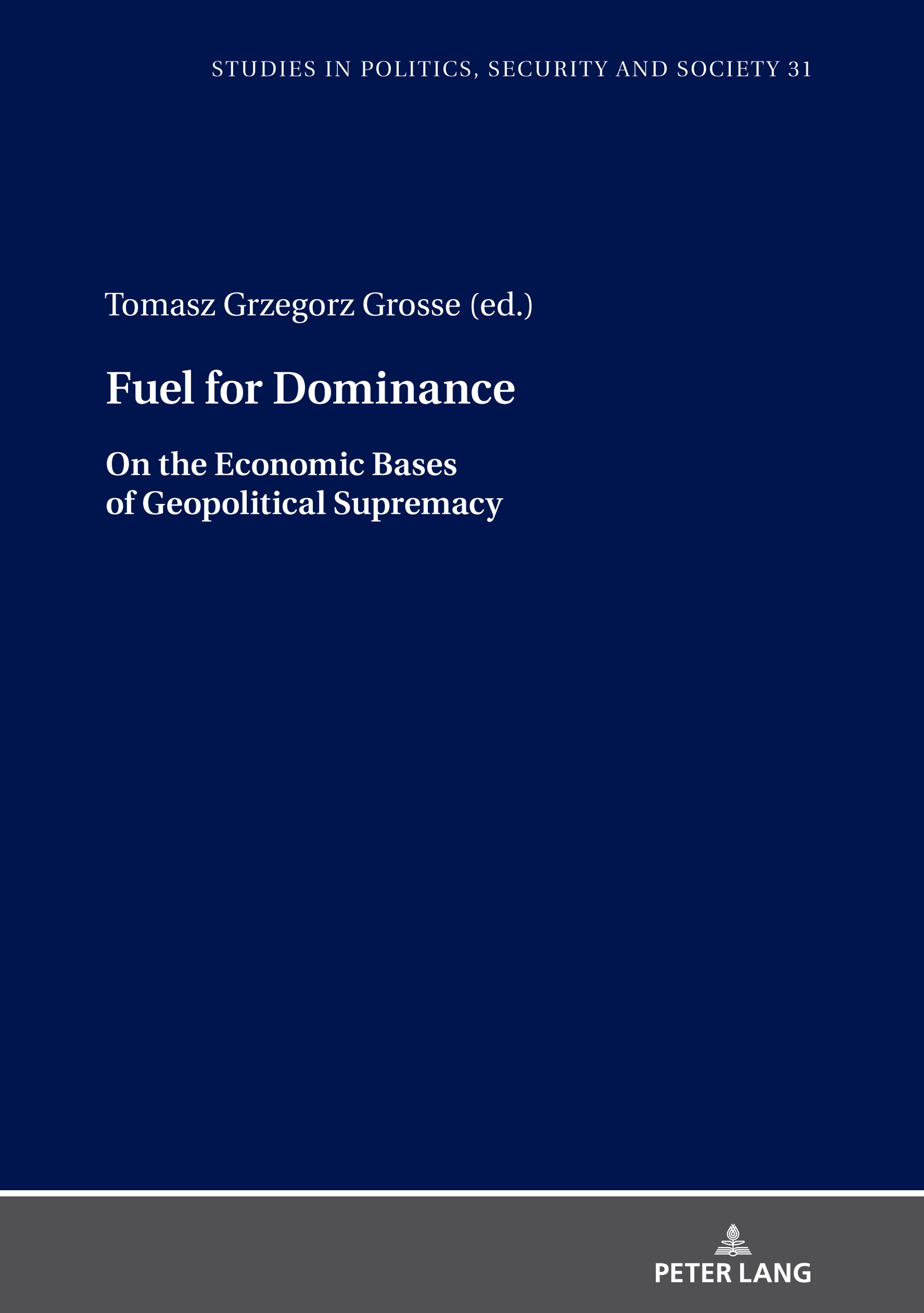
Fuel for Dominance The book is an attempt at assessing the importance of three economic areas IN creating power in international relations: energy sector, internationalization of currency and technologies with a military significance, which might potentially be "a fuel for dominance" and the instrument to gain geopolitical advantages. POLITICAL SCIENCE,American Government,Judicial Branch

Congress For Dummies Congress For Dummies helps you sort out what Congress does on a daily basis and what it all means to you, the citizen. It shows you how to get organized, make your voice heard, and influence legislation that might affect you. Full of helpful resources such as contact information for House and Senate offices, and smart, straightforward explanations of the legislative process, this book is everything you need to understand Congress and get involved in your government. Whether you just want to know how government works, or you want to get involved to change your country, this simple guide covers all the ins and outs of Congress. It’s a nonpartisan look at Congress that includes forewords by Speaker of the House Dennis Hastert and Senate Minority Leader Tom Daschle. Inside you’ll find easy explanations and helpful tips on how to: Get involved in the democratic process Influence legislation that’s important to you Understa nd Congress and the media Contact your senators and representatives Check out Congress in action, in person Deal with congressional staff Expert author David Silverberg — Managing Editor and a columnist at the Washington weekly The Hill — takes the mystery out of getting something done in Congress, introducing you to the players and explaining everything from legislation and lobbying to caucuses and coalitions. Written with the citizen advocate in mind, this helpful guide gives regular people the tools and knowledge they need to achieve their aims. Inside, you’ll discover: How the three branches of government work together How to register your opinion with your elected officials How the legislative process works — from idea to law How debates, conferences, and vetoes work How budgeting and appropriations work How to get the most effect from your political contributions How the lobbying process works How to advocate for legislation How to deal with congressional staffers How to make use of congressional services Getting something done in the messy confusion of democracy and bureaucracy is no easy task. Full of the kind of information and knowledge that Washington insiders take for granted, Congress For Dummies levels the playing field so that regular people — just like you — can make a difference, too. POLITICAL SCIENCE,American Government,Legislative Branch
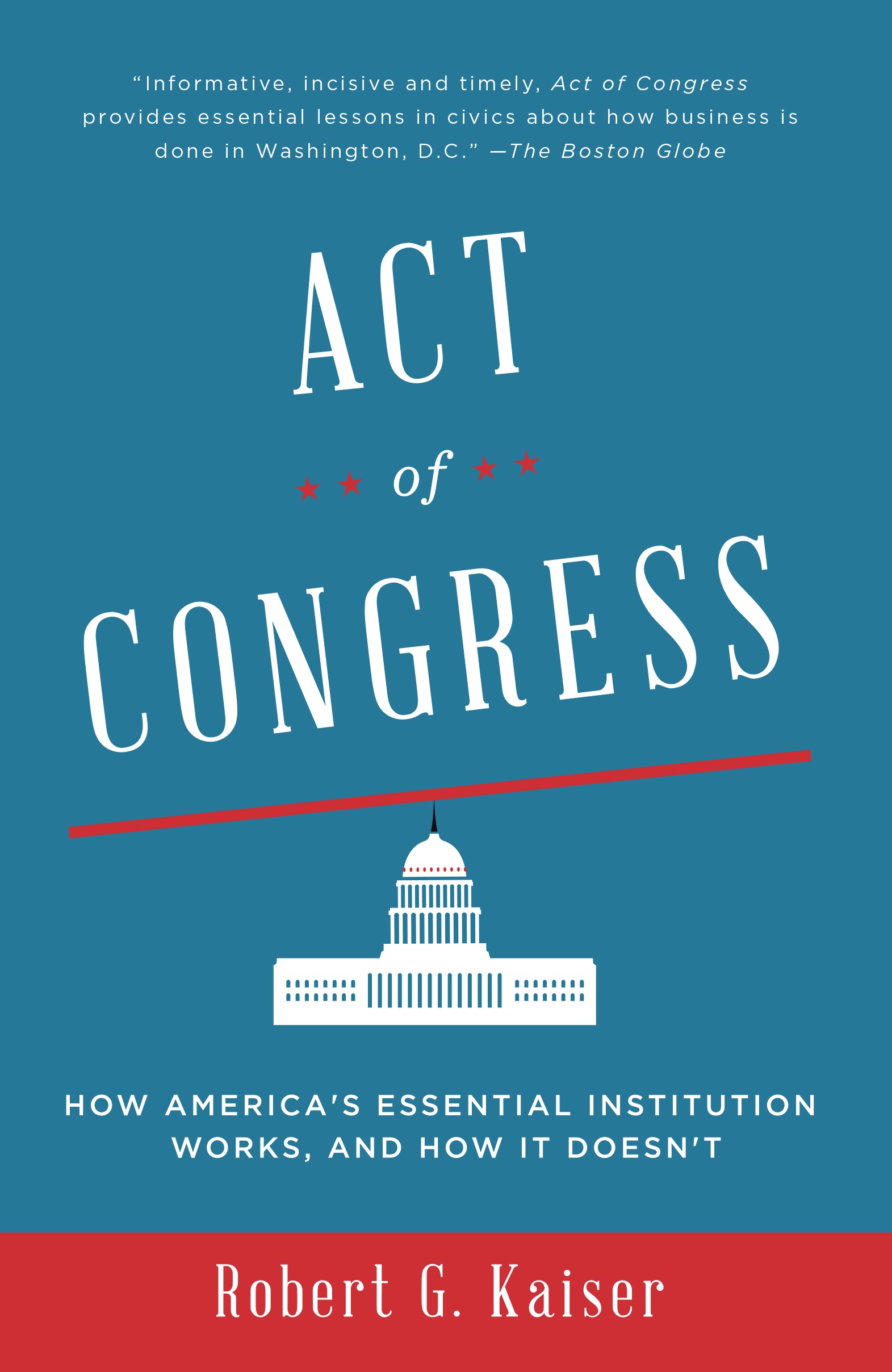
Act of Congress A Washington Post Notable Book An eye-opening account of how Congress today really works—and how it doesn’t— Act of Congress focuses on two of the major players behind the sweeping financial reform bill enacted in response to the Great Crash of 2008: colorful, wisecracking congressman Barney Frank, and careful, insightful senator Christopher Dodd, both of whom met regularly with Robert G. Kaiser during the eighteen months they worked on the bill. In this compelling narrative, Kaiser shows how staffers play a critical role, drafting the legislation and often making the crucial deals. Kaiser’s rare insider access enabled him to illuminate the often-hidden intricacies of legislative enterprise and shows us the workings of Congress in all of its complexity, a clearer picture than any we have had of how Congress works best—or sometimes doesn’t work at all. POLITICAL SCIENCE,American Government,Legislative Branch

The Art of Lobbying Often the whipping boys of politicians and pundits, lobbyists are the recipients of lampooning stump portrayals and sensationalized news coverage. Little attention is given to how most lobbyists simply do their job or become effective at what they do. Whether it’s helping staff draft legislative language, providing members with quality policy and political information, or just being a good listener, lobbyists must build and maintain relationships. If they do, they’ll succeed in advancing their policy objectives within the give-and-take process of the American legislative system. The Art of Lobbying examines strategies and techniques from the perspective of those who are lobbied—the people who know what resonates and what falls upon deaf ears in congressional offices. A former longtime lobbyist himself, Levine has interviewed more than 40 current or former members of Congress, along with their staffers, to give a thorough review of the relevant academic literature and offer a behind-the-scenes perspective on what constitutes the art of lobbying. POLITICAL SCIENCE,American Government,Legislative Branch
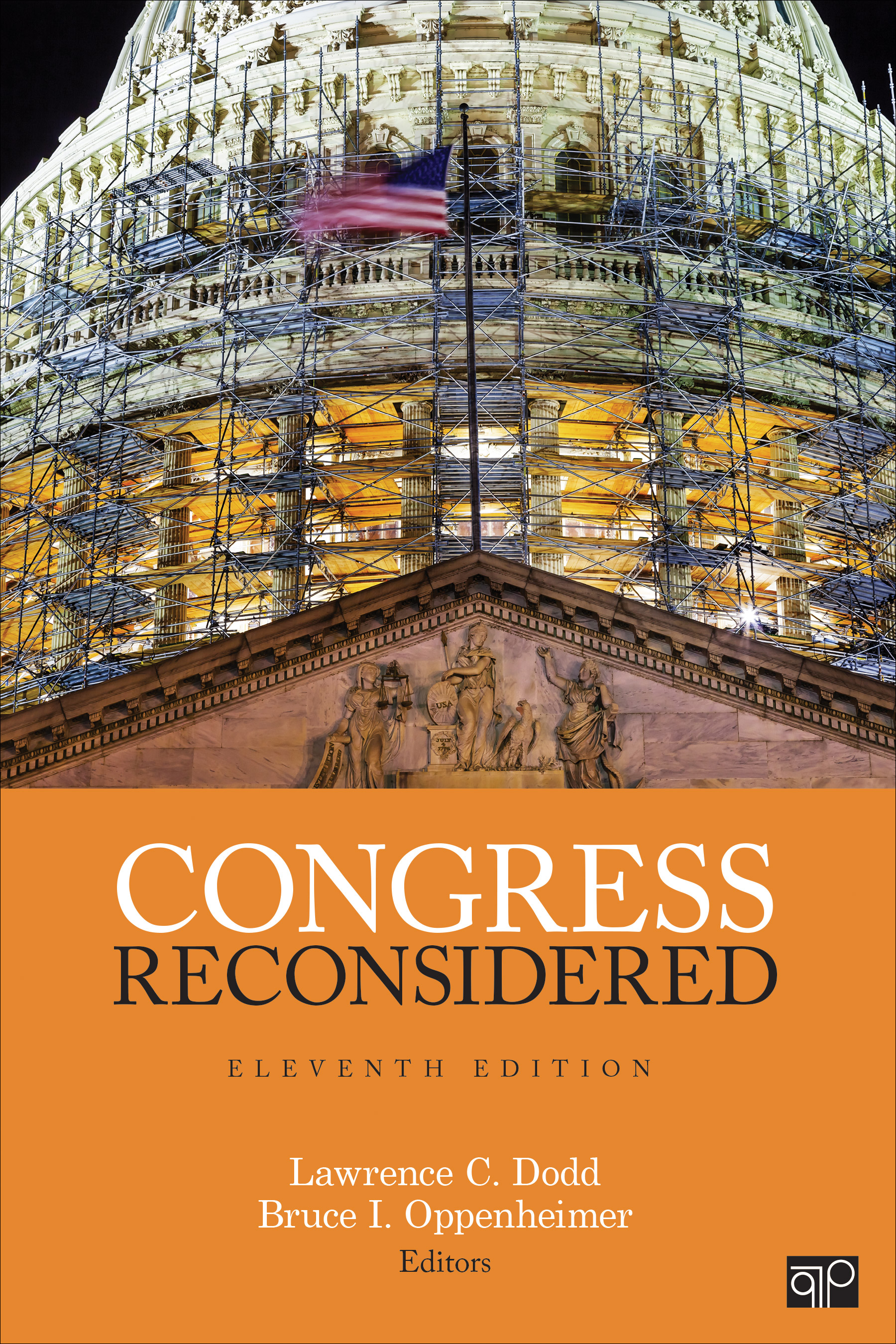
Congress Reconsidered For almost four decades, the editors of Congress Reconsidered, Lawrence C. Dodd and Bruce I. Oppenheimer have delivered the best contemporary work from leading congressional scholars in a form that is both analytical and accessible. The tradition continues in this Eleventh Edition as contributing authors focus on the many ways Congress has changed over time and examine the conditions that foster these developments. Some of the most noted names in congressional studies address topics from broad dynamics affecting the institution, elections and constituencies, parties and internal organization, inter-branch relations, and policymaking. This new edition also ends with a capstone chapter on the milestone 2016 elections. Simply put, this bestselling volume remains on the cutting edge of scholarship, identifying patterns of change in Congress and placing those patterns in context. POLITICAL SCIENCE,American Government,Legislative Branch

Back in the Game The "gripping and inspiring" true story (Washington Examiner) of how Congressman Steve Scalise survived a political mass shooting and returned to Congress with the help of his friends, family, and faith. On the morning of June 14, 2017, at a practice field for the annual Congressional Baseball Game, a man opened fire on the Republican team, wounding five and nearly killing Louisiana congressman Steve Scalise. In heart-pounding fashion, Scalise's minute-by-minute account tells not just his own harrowing story, but the stories of heroes who emerged in the seconds after the shooting began and worked to save his life and the lives of his colleagues and teammates. Scalise delves into the backgrounds of each hero, seeking to understand how everyone wound up right where they needed to be, right when they needed to be there, and in possession of just the knowledge and experience they needed in order to save his life. Scalise takes us through each miracle, and each person who experienced it. He brings us the story of Rep. Brad Wenstrup, an Army Reserve officer and surgeon whose combat experience in Iraq uniquely prepared him for the attack that morning; of the members of his security detail, who acted with nearly cinematic courage; of the police, paramedics, helicopter pilots, and trauma team who came together to save his life. Most important, it tells of the citizens from all over America who came together in ways big and small to help one grateful man, and whose prayers lifted up Scalise during the worst days of his hospitalization. As we follow the gripping, poignant, and ultimately inspiring story, we begin to realize what Scalise learned firsthand in real time: that Americans look out for each other, and that there is far more uniting us than dividing us. POLITICAL SCIENCE,American Government,Legislative Branch
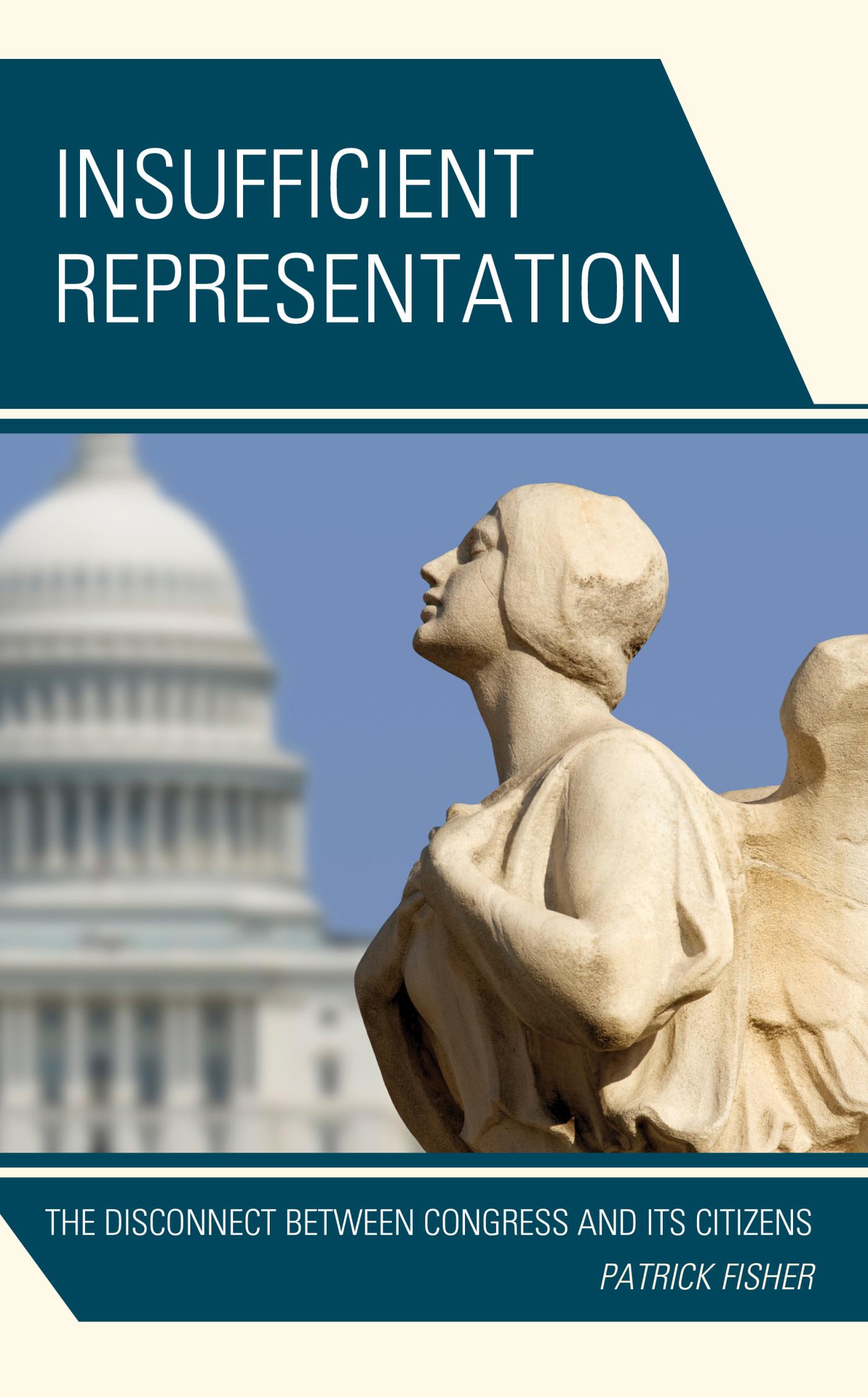
Insufficient Representation This book analyzes the demographic disconnect between the American public and congressional representation. The fact that Congress does not equally represent all citizens is critical to understanding the disillusionment most Americans hold toward the contemporary Congress. POLITICAL SCIENCE,American Government,Legislative Branch

Inside Congress Required reading for anyone who wants to understand how to work within Congress The House and Senate have unique rules and procedures to determine how legislation moves from a policy idea to law. Evolved over the last 200 years, the rules of both chambers are designed to act as the engine for that process. Each legislative body has its own leadership positions to oversee this legislative process. To the novice, whether a newly elected representative, a lawmaker’s staff on her first day at work, or a constituent visiting Washington, the entire process can seem incomprehensible. What is an open rule for a House Appropriations bill and how does it affect consideration? Why are unanimous consent agreements needed in the Senate? The authors of Inside Congress, all congressional veterans, have written the definitive guide to how Congress really works. It is the accessible and necessary resource to understanding and interpreting procedural tools, arcane precedents, and the role of party politics in the making of legislation in Congress. POLITICAL SCIENCE,American Government,Legislative Branch

Bureaucratic Politics and Foreign Policy The first edition of Bureaucratic Politics and Foreign Policy is one of the most successful Brookings titles of all time. This thoroughly revised version updates that classic analysis of the role played by the federal bureaucracycivilian career officials, political appointees, and military officersand Congress in formulating U.S. national security policy, illustrating how policy decisions are actually made. Government agencies, departments, and individuals all have certain interests to preserve and promote. Those priorities, and the conflicts they sometimes spark, heavily influence the formulation and implementation of foreign policy. A decision that looks like an orchestrated attempt to influence another country may in fact represent a shaky compromise between rival elements within the U.S. government. The authors provide numerous examples of bureaucratic maneuvering and reveal how they have influenced our international relations. The revised edition includes new examples of bureaucratic politics from the past three decades, from Jimmy Carter's view of the State Department to conflicts between George W. Bush and the bureaucracy regarding Iraq. The second edition also includes a new analysis of Congress's role in the politics of foreign policymaking. POLITICAL SCIENCE,American Government,Legislative Branch
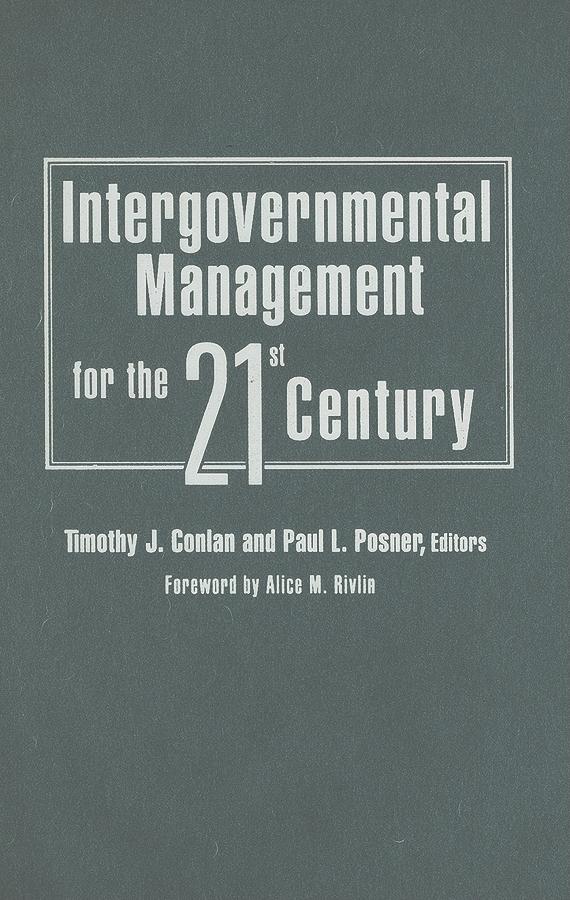
Intergovernmental Management for the 21st Century A Brookings Institution Press and the National Academy of Public Administration publication America's complex system of multi-layered government faces new challenges as a result of rapidly changing economic, technological, and demographic trends. An aging population, economic globalization, and homeland security concerns are among the powerful factors testing the system's capacity and flexibility. Major policy challenges and responses are now overwhelmingly intergovernmental in nature, and as a result, the fortunes of all levels of government are more intertwined and interdependent than ever before. This volume, cosponsored by the National Academy of Public Administration (NAPA), defines an agenda for improving the performance of America's intergovernmental system. The early chapters present the current state of practice in intergovernmental relations, including discussion of trends toward centralization, devolution, and other power-sharing arrangements. The fiscal underpinnings of the system are analyzed, along with the long-term implications of current trends in financing at all levels. The authors identify the principal tools used to define intergovernmental managementgrants, mandates, preemptionsin discussing emerging models and best practices in the design and management of those tools. In tergovernmental Management for the 21st Century applies these crosscutting themes to critical policy areas where intergovernmental management and cooperation are essential, such as homeland security, education, welfare, health care, and the environment. It concludes with an authoritative assessment of the system's capacity to govern, oversee, and improve. Contributors include Jocelyn Johnston (American University), Shelley Metzenbaum (University of Maryland), Richard Nathan (SUNY at Albany), Barry Rabe (University of Michigan), Beryl Radin (American University), Alice Rivlin (Brookings Institution), Ray Sheppach (National Governors Association), Frank Shafroth (George Mason University), Troy Smith (BYUHawaii), Carl Stenberg (University of Nor POLITICAL SCIENCE,American Government,Legislative Branch
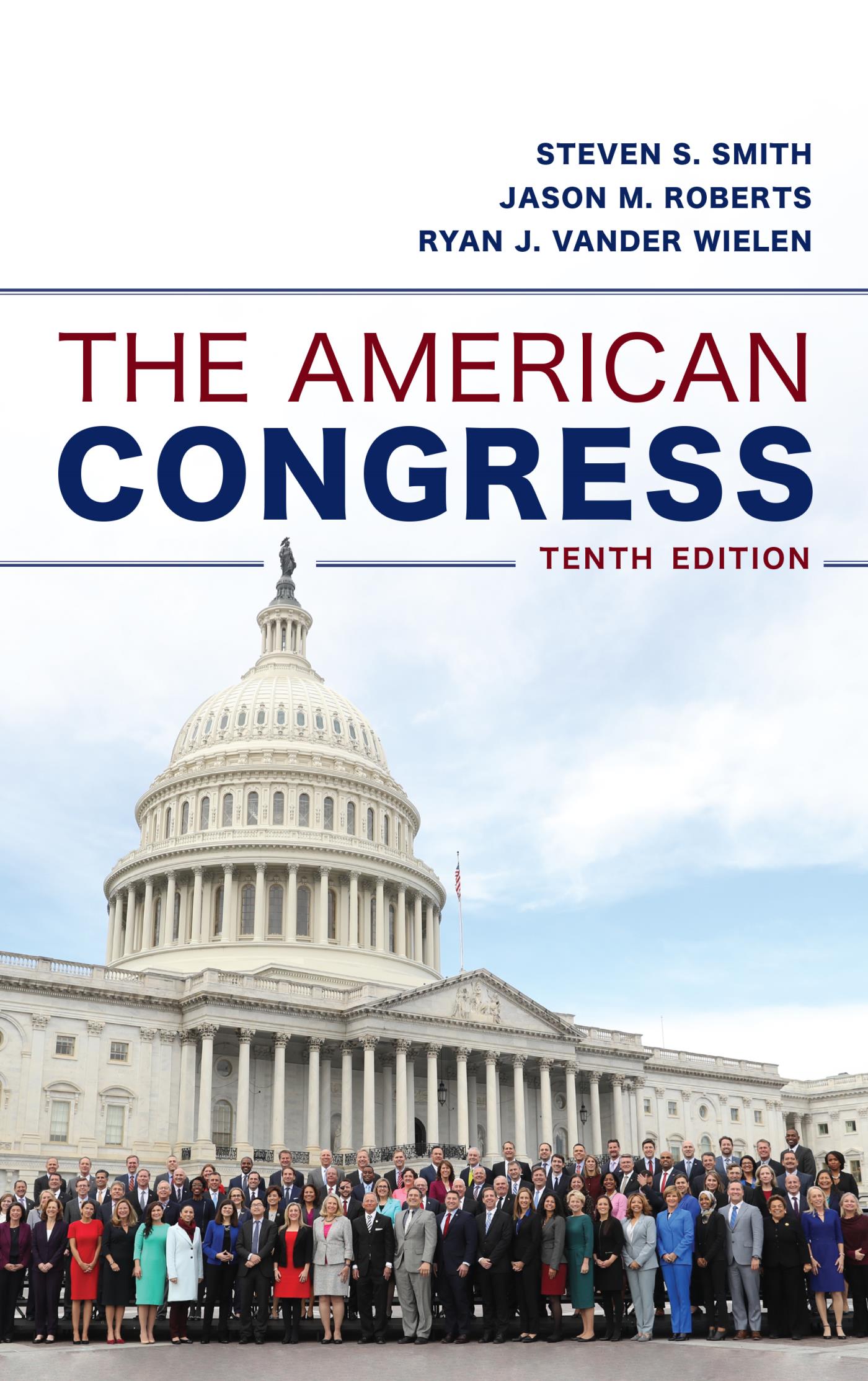
The American Congress The tenth edition of this core textbook provides a fresh perspective and a crisp introduction to congressional politics. Informed by the authors’ Capitol Hill experience and scholarship, the text emphasizes the importance of a strong legislature and offers discussion questions and further reading. POLITICAL SCIENCE,American Government,Legislative Branch
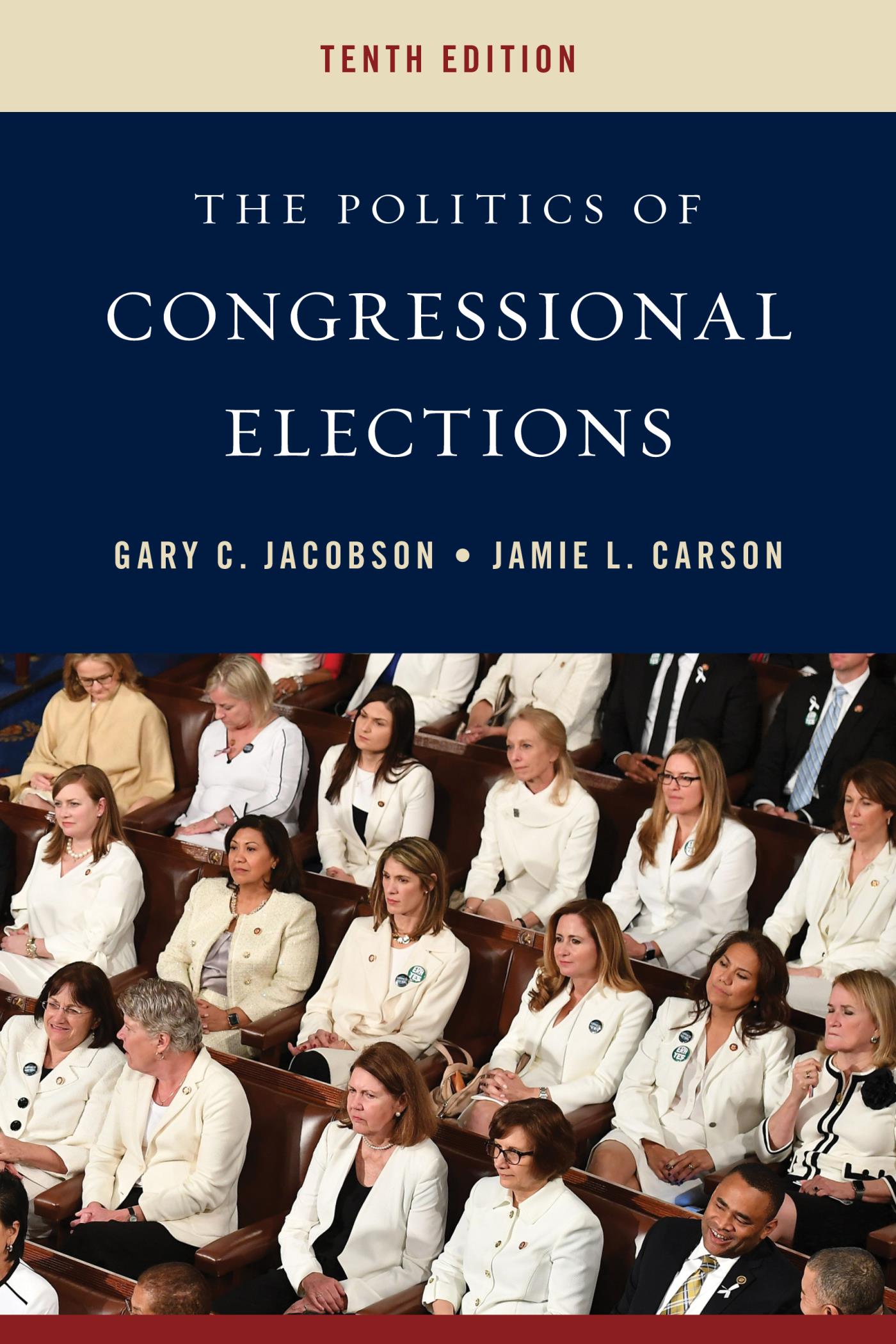
The Politics of Congressional Elections Pairing historical data analysis and original research with fundamental concepts of representation and responsibility, The Politics of Congressional Elections presents students with the tools to evaluate representative government, as well as their own role in the electoral process. POLITICAL SCIENCE,American Government,Legislative Branch

Congress and Its Members The Gold Standard for Congress Courses for Over Thirty Years Congress and Its Members by Roger H. Davidson, Walter J. Oleszek, Frances E. Lee, and Eric Schickler offers you comprehensive coverage of the U.S. Congress and the legislative process by examining the tension between Congress as a lawmaking institution and as a collection of politicians constantly seeking re-election. The highly anticipated Seventeenth Edition considers the 2018 elections and the Trump administration, discussing the agenda of the new Congress, White House–Capitol Hill relations, party and committee leadership changes, judicial appointments, and partisan polarization, in addition to covering changes to budgeting, campaign finance, lobbying, public attitudes about Congress, reapportionment, rules, and procedures. Always balancing great scholarship with currency, this bestseller features lively case material along with relevant data, charts, exhibits, maps, and photos. POLITICAL SCIENCE,American Government,Legislative Branch

Doesn't Hurt to Ask #1 NEW YORK TIMES BESTSELLER • Former congressman and prosecutor Trey Gowdy teaches you how to effectively communicate and persuade on the issues that matter most to you, drawing on his experience in the courtroom and the halls of Congress. “A must-read for people who want to learn how best to succeed.”—Dana Perino, Fox News host and bestselling author of And the Good News Is . . . You do not need to be in a courtroom to advocate for others. You do not need to be in Congress to champion a cause. From the boardroom to the kitchen table, opportunities to make your case abound, and Doesn’t Hurt to Ask shows you how to seize them. By blending gripping case studies from nearly two decades in a courtroom and four terms in national politics with personal stories and practical advice, Trey Gowdy walks you through the tools and the mindset needed to effectively communicate your message. Along the way, Gowdy reflects on the moments in his life when he learned the most about how to argue and convince. He recounts his missteps during his first murder trial, the conversation that changed his view on criminal justice reform, and what he learned while questioning James Comey and Secretary Hillary Clinton. Sharing the techniques he perfected advocating in law and politics, Gowdy helps you identify your objective, understand your personal jury, and engage in the art of questioning so you can be heard, be understood, and, ultimately, move others. Whether it’s getting a boss to take a chance on your idea, convincing someone to support your cause, or urging a child to invest more effort in an important task, movement requires persuasion. Doesn’t Hurt to Ask shows you how to persuade, no matter the jury and no matter the cause. POLITICAL SCIENCE,American Government,Legislative Branch

Local Elections and the Politics of Small-Scale Democracy Local government is the hidden leviathan of American politics: it accounts for nearly a tenth of gross domestic product, it collects nearly as much in taxes as the federal government, and its decisions have an enormous impact on Americans' daily lives. Yet political scientists have few explanations for how people vote in local elections, particularly in the smaller cities, towns, and suburbs where most Americans live. Drawing on a wide variety of data sources and case studies, this book offers the first comprehensive analysis of electoral politics in America's municipalities. Arguing that current explanations of voting behavior are ill suited for most local contests, Eric Oliver puts forward a new theory that highlights the crucial differences between local, state, and national democracies. Being small in size, limited in power, and largely unbiased in distributing their resources, local governments are "managerial democracies" with a distinct style of electoral politics. Instead of hinging on the partisanship, ideology, and group appeals that define national and state elections, local elections are based on the custodial performance of civic-oriented leaders and on their personal connections to voters with similarly deep community ties. Explaining not only the dynamics of local elections, Oliver's findings also upend many long-held assumptions about community power and local governance, including the importance of voter turnout and the possibilities for grassroots political change. POLITICAL SCIENCE,American Government,Local

Virginia Government Equally at home as a companion to an introductory text or as a stand-alone resource, Virginia Government offers an excellent introduction to the political institutions, actors, and policy processes of the Old Dominion State. Paying special attention to the governing arrangements that make Virginia unique, from statewide city-county separation to a single-term governor to shifting electoral alignments, Peaslee and Swartz strike the perfect balance, combining necessary background and historical analysis with current events and policy issues to make the information relevant and engaging for today’s students. Grounded in the comparative method, the text provides useful comparisons with governing institutions, political processes, and public polices in other states and localities. POLITICAL SCIENCE,American Government,Local
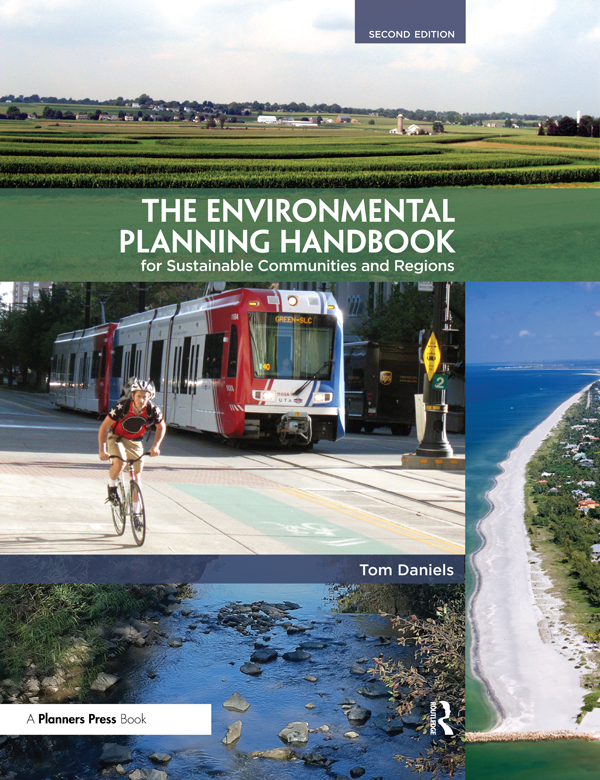
Environmental Planning Handbook Environmental protection is a global issue. But most of the action is happening at the local level. How can communities keep their air clean, their water pure, and their people and property safe from climate and environmental hazards? Newly updated, The Environmental Planning Handbook gives local governments, nonprofits, and citizens the guidance they need to create an action plan they can implement now. It’s essential reading for a post-Katrina, post-Sandy world. POLITICAL SCIENCE,American Government,Local

The Politics of Local Government The book combines a review of scholarly sources as well as the experiences of an elected government official to examine the politics behind local government. Conflicts that take place at the local level as well as opportunities to make meaningful change are addressed. POLITICAL SCIENCE,American Government,Local
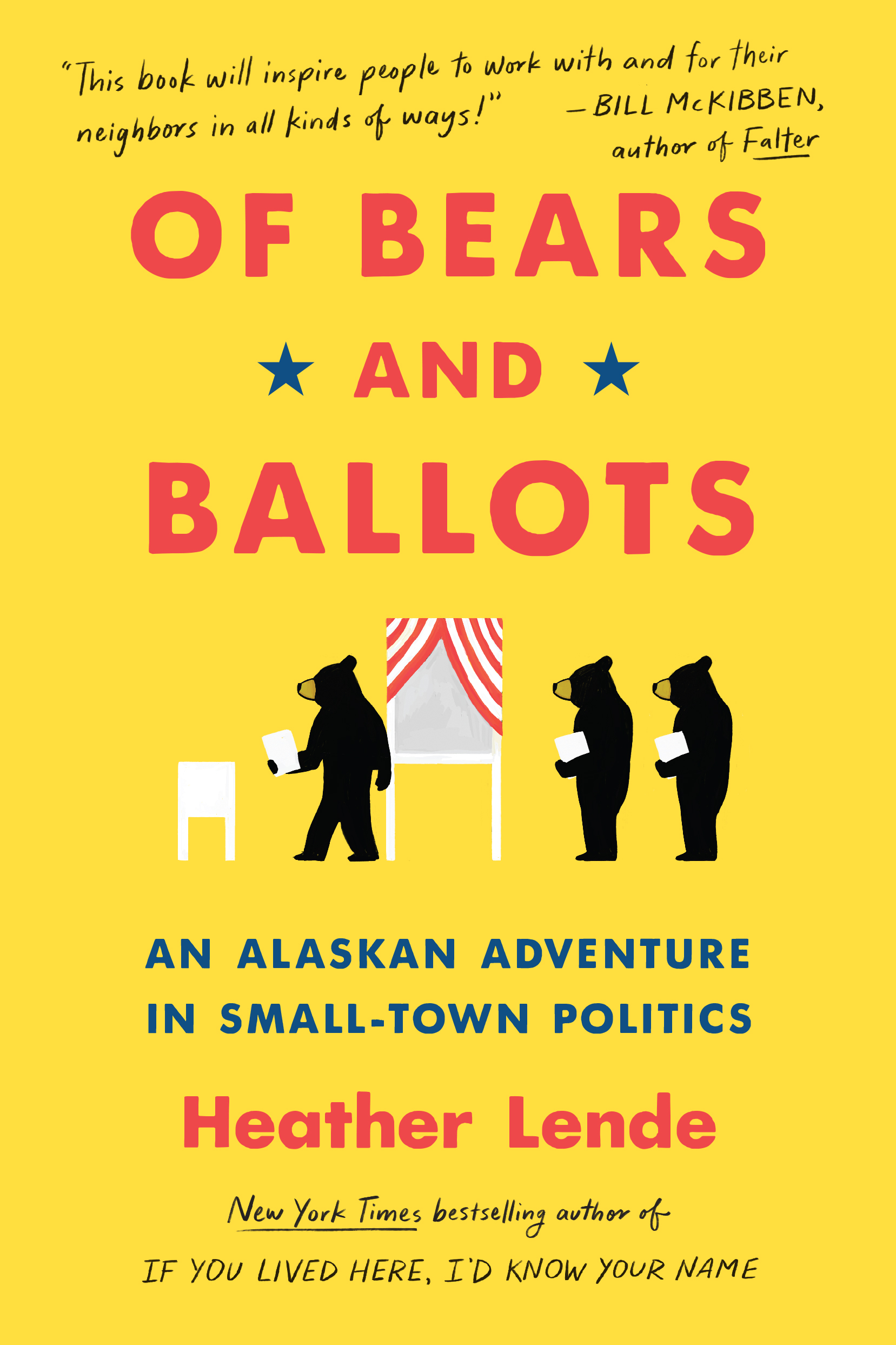
Of Bears and Ballots “This book will inspire people to work with and for their neighbors in all kinds of ways!” —Bill McKibben, author of Falter The writer whom the Los Angeles Times calls “part Annie Dillard, part Anne Lamott” now brings us her quirky and compassionate account of holding local office. Heather Lende was one of the thousands of women inspired to take a more active role in politics during the past few years. Though her entire campaign for assembly member in Haines, Alaska, cost less than $1,000, she won! But tiny, breathtakingly beautiful Haines—a place accessible from the nearest city, Juneau, only by boat or plane—isn’t the sleepy town that it appears to be: from a bitter debate about the expansion of the fishing boat harbor to the matter of how to stop bears from rifling through garbage on Main Street to the recall campaign that targeted three assembly members, including Lende, we witness the nitty-gritty of passing legislation, the lofty ideals of our republic, and how the polarizing national politics of our era play out in one small town. With an entertaining cast of offbeat but relatable characters, Of Bears and Ballots is an inspirational tale about what living in a community really means, and what we owe one another. POLITICAL SCIENCE,American Government,Local
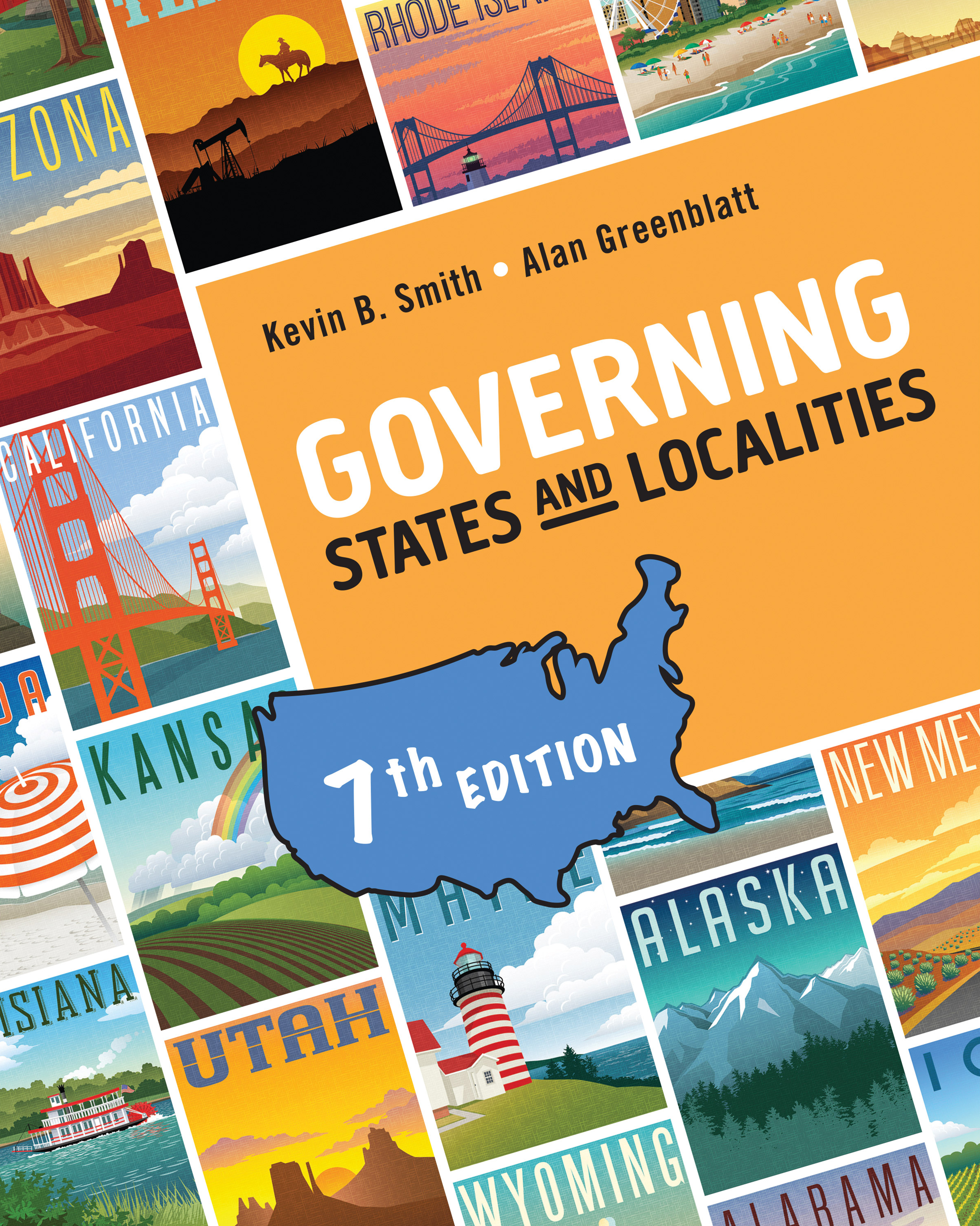
Governing States and Localities The trusted and proven Governing States and Localities guides you through the contentious environment of state and local politics and focuses on the role that economic and budget pressures play on issues facing state and local governments. With their engaging journalistic writing and crisp storytelling, Kevin B. Smith and Alan Greenblatt employ a comparative approach to explain how and why states and localities are both similar and different. The Seventh Edition is thoroughly updated to account for such major developments as state vs. federal conflicts over immigration reform, school shootings, and gun control; the impact of the Donald Trump presidency on intergovernmental relations and issues of central interest to states and localities; and the lingering effects of the Great Recession. POLITICAL SCIENCE,American Government,Local
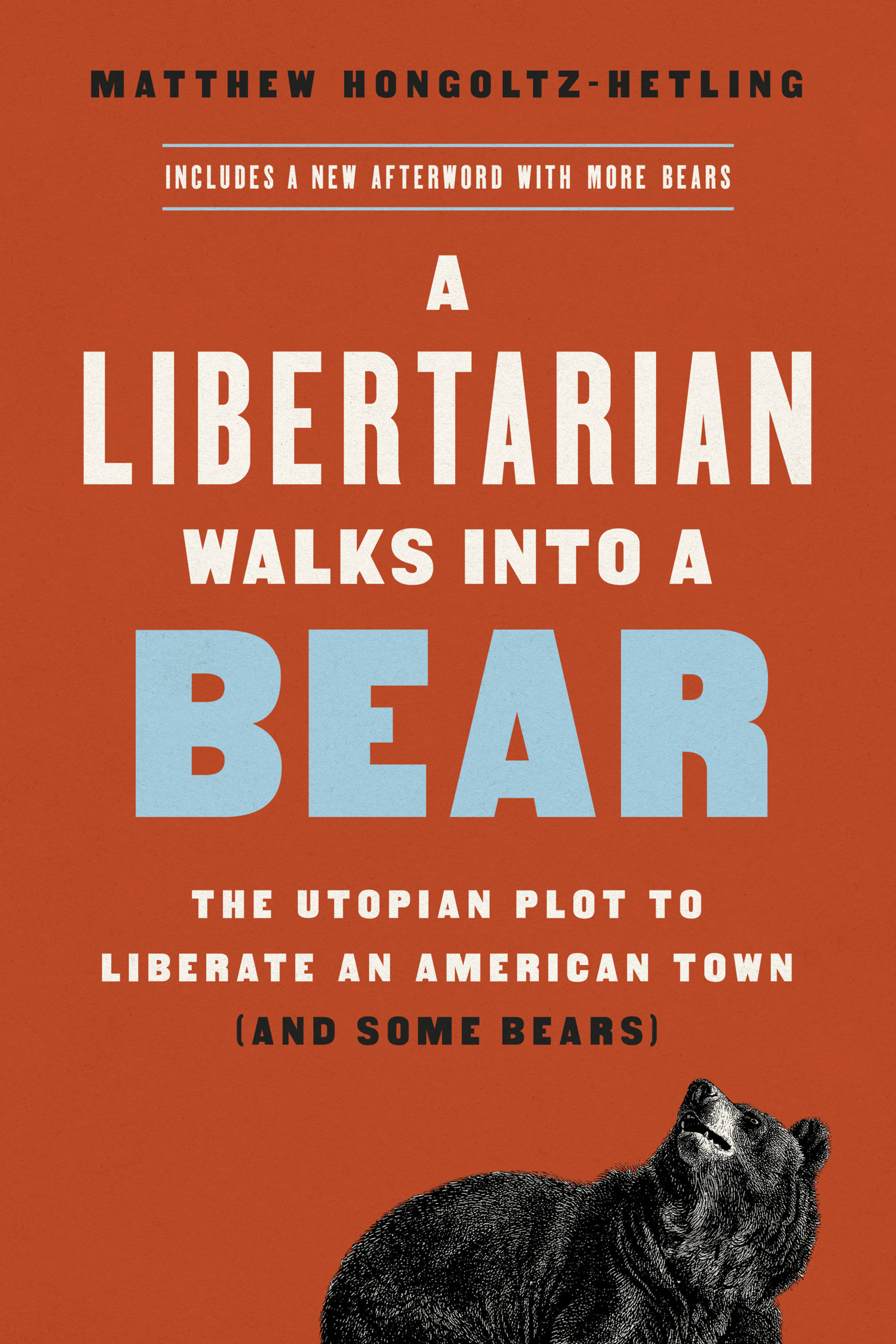
A Libertarian Walks Into a Bear A tiny American town's plans for radical self-government overlooked one hairy detail: no one told the bears. Once upon a time, a group of libertarians got together and hatched the Free Town Project, a plan to take over an American town and completely eliminate its government. In 2004, they set their sights on Grafton, NH, a barely populated settlement with one paved road. When they descended on Grafton, public funding for pretty much everything shrank: the fire department, the library, the schoolhouse. State and federal laws became meek suggestions, scarcely heard in the town's thick wilderness. The anything-goes atmosphere soon caught the attention of Grafton's neighbors: the bears. Freedom-loving citizens ignored hunting laws and regulations on food disposal. They built a tent city in an effort to get off the grid. The bears smelled food and opportunity. A Libertarian Walks Into a Bear is the sometimes funny, sometimes terrifying tale of what happens when a government disappears into the woods. Complete with gunplay, adventure, and backstabbing politicians, this is the ultimate story of a quintessential American experiment -- to live free or die, perhaps from a bear. POLITICAL SCIENCE,American Government,Local

Electoral Capitalism Electoral Capitalism brings new perspective to the crisis of inequality during the Gilded Age. Examining how party leaders governed by accumulating wealth through the spoils system, Broxmeyer places in historical context debates over capitalism and democracy that continue to resonate today. POLITICAL SCIENCE,American Government,Local
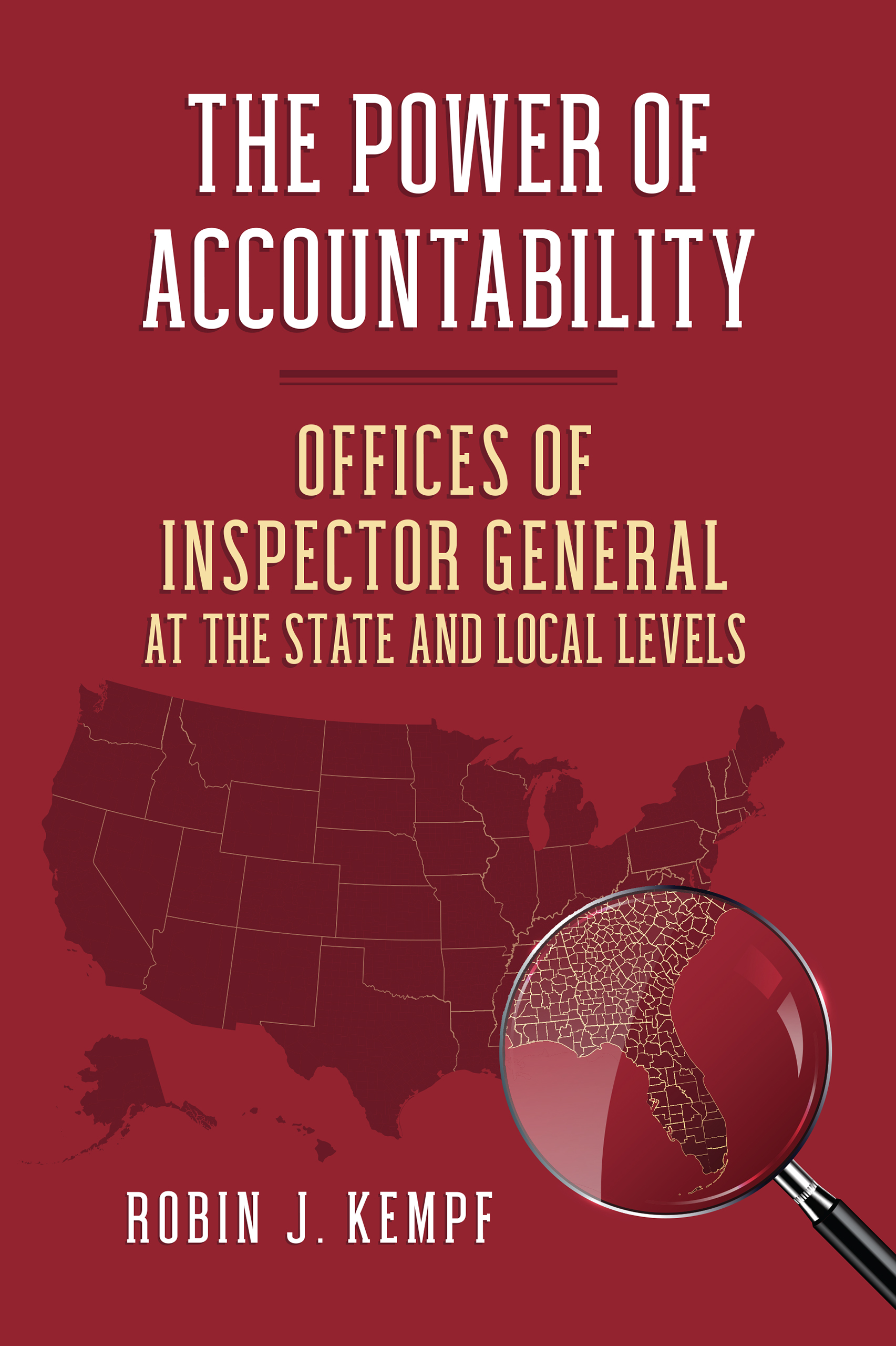
The Power of Accountability Migrant children separated from their parents. A scheme to defraud Cook County using property tax breaks. An undisclosed thirty-year business relationship between city officials in Baltimore. These are the sorts of headlines regularly generated by offices of inspector general (OIGs)—bureaucratic units dedicated to government accountability that are commonly independent of the agencies they are charged with overseeing. In 1976, OIGs were virtually unheard of and were largely at the federal level, but today there are more than 170 OIGs overseeing state and local government entities. Why have OIGs been so widely adopted, and what do they do? How do they contribute to accountability, and what are their limitations? In The Power of Accountability Robin J. Kempf sets out to address these questions with empirical data and to examine the conflicts that have led to variations in the design and implementation of OIGs. In doing so she explores the power of the concept of the inspector general: an institutional model for keeping subnational government units accountable to the public. As more and more government entities have created offices of inspector general, practitioners in this developing field have recommended an archetypal structure for these agencies that assures their authority and independence. Why then, The Power of Accountability asks, have so many states and localities incorporated significant deviations from this recommended model in their design? Through an extensive review of government websites, laws, and ordinances; original surveys of the identified OIGs; legislative histories; and interviews with thirty-eight OIG staff in eight states, Kempf analyzes why OIGs have proliferated, why and how they work differently in various jurisdictions, and what effect these variations in design have on the effectiveness of OIGs as a mechanism of accountability. The ever-expanding call for accountability in government drives the increasing demand for offices of inspector general, which necessarily entails intense political maneuvering. The Power of Accountability is a uniquely useful resource for judging whether, under what circumstances, and how well OIGs fulfill their intended purpose and serve the public interest. POLITICAL SCIENCE,American Government,Local

The Complete Idiot's Guide to U.S. Government and Politics The governed must know their government. Understanding how our government functions and the political forces that influence it is vital for all Americans. As a comprehensive overview and history of the subject, this book is designed to help anyone interested in learning about our government and the origins of its complex inner workings, our political system, and key elements that have affected our growth as a nation, all while serving as the best supplementary reading a student can get. - Author is an experienced Advanced Placement teacher - Students looking to take AP exams are a ready audience, along with citizenship applicants and CNN junkies - Large renewable market - Suitable as supplemental reading for coursework POLITICAL SCIENCE,American Government,National
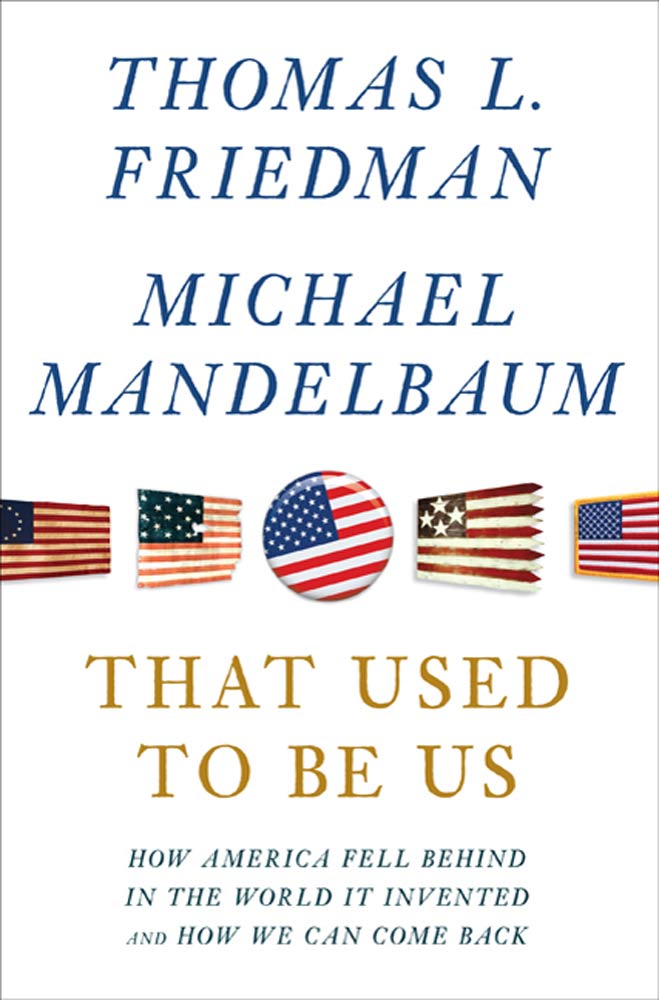
That Used to Be Us America is in trouble. We face four major challenges on which our future depends, and we are failing to meet them—and if we delay any longer, soon it will be too late for us to pass along the American dream to future generations. In That Used to Be Us, Thomas L. Friedman, one of our most influential columnists, and Michael Mandelbaum, one of our leading foreign policy thinkers, offer both a wake-up call and a call to collective action. They analyze the four challenges we face—globalization, the revolution in information technology, the nation's chronic deficits, and our pattern of excessive energy consumption—and spell out what we need to do now to sustain the American dream and preserve American power in the world. They explain how the end of the Cold War blinded the nation to the need to address these issues seriously, and how China's educational successes, industrial might, and technological prowess remind us of the ways in which "that used to be us." They explain how the paralysis of our political system and the erosion of key American values have made it impossible for us to carry out the policies the country urgently needs. And yet Friedman and Mandelbaum believe that the recovery of American greatness is within reach. They show how America's history, when properly understood, offers a five-part formula for prosperity that will enable us to cope successfully with the challenges we face. They offer vivid profiles of individuals who have not lost sight of the American habits of bold thought and dramatic action. They propose a clear way out of the trap into which the country has fallen, a way that includes the rediscovery of some of our most vital traditions and the creation of a new thirdparty movement to galvanize the country. That Used to Be Us is both a searching exploration of the American condition today and a rousing manifesto for American renewal. POLITICAL SCIENCE,American Government,National

50 American Revolutions You're Not Supposed to Know Since when was it unpatriotic to dissent? Why is it “un-American†to question our government’s policies? And how did the Far Right manage to claim the flag exclusively for itself? A book that the country desperately needs, 50 American Revolutions is a concise, quick guide to the people and events in our country’s history that progressives and anyone not impressed by the radical Right’s warped version of patriotism can be proud of. Author Mickey Z begins with Thomas Paine’s revolutionary manifesto Common Sense, written anonymously as a pamphlet in January 1776 and read by every member of Congress, and goes on to highlight the most notable people and events in the history of the United States, right through to the families of 9/11 victims in the group Peaceful Tomorrows questioning the connection between the events of that day and the United States’ subsequent acts of aggression in Iraq. In addition to concise essays on everything and everyone from the Bill of Rights to disability rights, Coxey’s Army to Public Enemy, Mickey also highlights important milestones along the timeline of the book, making for a complete picture of US history, good with bad. As with Russ Kick’s ultra-popular 50 Things You’re Not Supposed To Know, 50 American Revolutions is perfectly sized for handbags and coat pockets (it’s the same size as a CD), it’s a tremendous gift for anyone whose idea of patriotism needs some revision. POLITICAL SCIENCE,American Government,National

Clouds of Secrecy In the 1970s Americans learned for the first time that they had been used for decades as unsuspecting guinea pigs in a series of astonishing experiments conducted by the US Army. Military researchers had been secretly spraying clouds of bacteria over populated areas in order to study America''s vulnerability to biological weapons. Many civilians have suffered illness, even death, as a consequence. POLITICAL SCIENCE,American Government,National

Great Again In this book (previously published as Crippled America), we’re going to look at the state of the world right now. It’s a terrible mess, and that’s putting it mildly. There has never been a more dangerous time. The politicians and special interests in Washington, DC are directly responsible for the mess we are in. So why should we continue listening to them? It’s time to bring America back to its rightful owners—the American people. I’m not going to play the same game politicians have been playing for decades—all talk, no action, while special interests and lobbyists dictate our laws. I am shaking up the establishment on both sides of the political aisle because I can’t be bought. I want to bring America back, to make it great and prosperous again, and to be sure we are respected by our allies and feared by our adversaries. It’s time for action. Americans are fed up with politics as usual. And they should be! In this book, I outline my vision to make America great again, including: how to fix our failing economy; how to reform health care so it is more efficient, cost-effective, and doesn’t alienate both doctors and patients; how to rebuild our military and start winning wars—instead of watching our enemies take over—while keeping our promises to our great veterans; how to ensure that our education system offers the resources that allow our students to compete internationally, so tomorrow’s jobseekers have the tools they need to succeed; and how to immediately bring jobs back to America by closing our doors to illegal immigrants, and pressuring businesses to produce their goods at home. This book is my blueprint for how to Make America Great Again. It’s not hard. We just need someone with the courage to say what needs to be said. POLITICAL SCIENCE,American Government,National

Debating Arab Authoritarianism Examines how political rule in Arab countries is effectuated, organized, and executed, and how authoritarianism works in practice and how it can be grasped conceptually. POLITICAL SCIENCE,American Government,National

The Everything American Government Book If the confusion following the last presidential election is any indication, the average citizen knows precious little about the democratic system and the laws that affect their daily lives. The Everything American Government Book unravels the complexities of our democracy and provides readers with the knowledge necessary to make the right decisions and take an active role in the management of their country. From the roots of American government and the challenges that have helped shape it over the years to its current structure and systems, this thoroughly researched work is ideal for anyone brushing up on civics, as well as students of all ages.Readers learn about: The personalities and events that gave rise to our current system The real significance of the Bill of Rights and the Constitution The functions of each branch of government and how they work together Private sector’s influence on public policy and decision-making Ways to get involved and make a difference Specially designed to inform and empower the average citizen during this critical election year, The Everything American Government Book provides the keys to understanding the ins and outs of the most powerful democracy in the world. POLITICAL SCIENCE,American Government,National
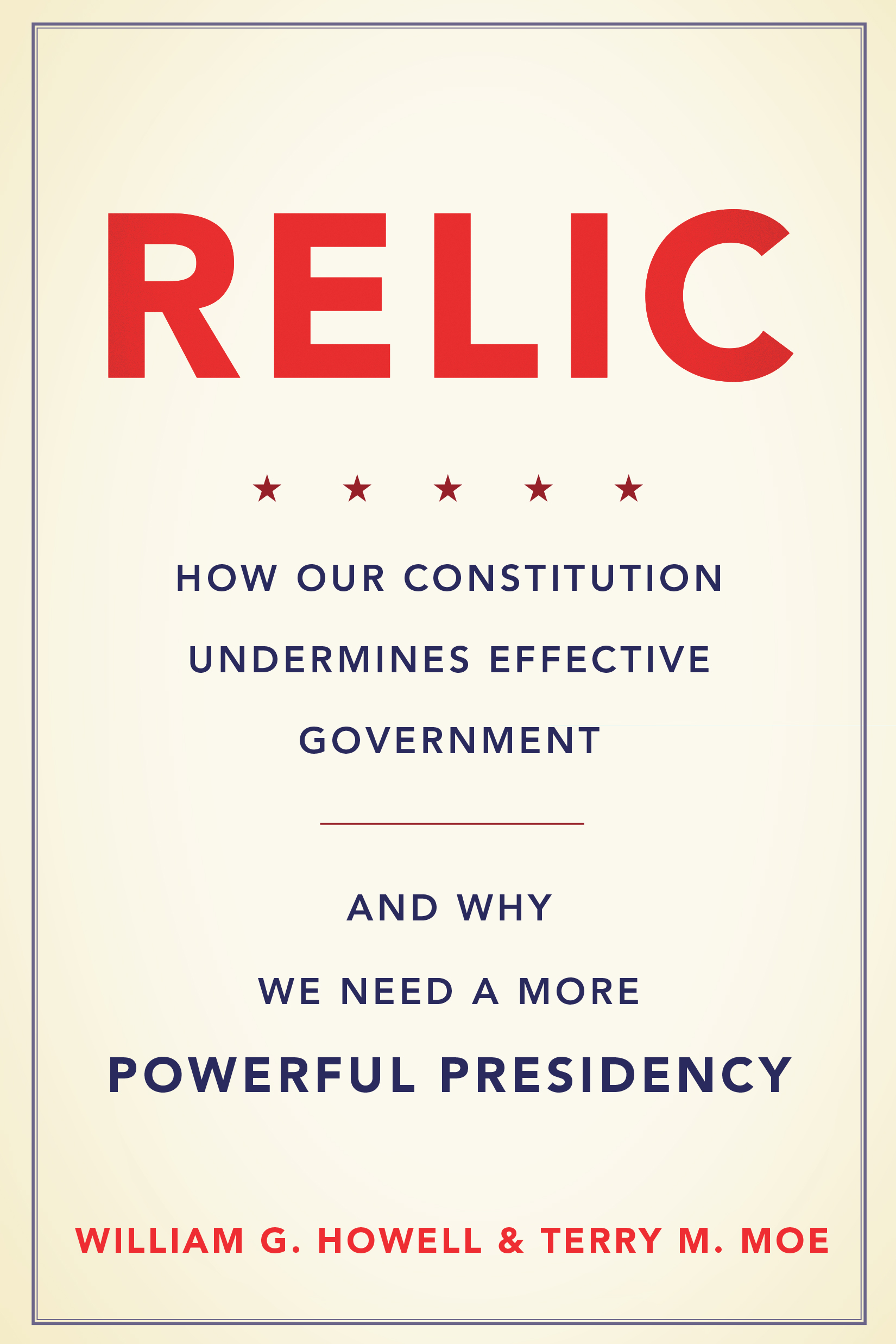
Relic Our government is failing us. From health care to immigration, from the tax code to climate change, our political institutions cannot deal effectively with the challenges of modern society. Why the dysfunction? Contemporary reformers single out the usual suspects, including polarization and the rise in campaign spending. But what if the roots go much deeper, to the nation's founding? In Relic, William G. Howell and Terry M. Moe point to the Constitution as the main culprit. The framers designed the Constitution some 225 years ago for a simple, agrarian society. But the government they created, with a parochial Congress at its center, is ill-equipped to address the serious social problems that arise in a complex, postindustrial nation. We are prisoners of the past, burdened with an antiquated government that cannot make effective policy, and often cannot do anything at all. The solution is to update the Constitution for modern times. This can be accomplished, Howell and Moe argue, through reforms that push Congress and all its pathologies to the periphery of the lawmaking process, and bring presidents -- whose concern for their legacy drives them to seek coherent policy solutions -- to the center of decision making. As Howell and Moe reveal, the key to effective government for modern America is a more powerful presidency. Relic is a provocative and essential book for our era of political dysfunction and popular despair. It sheds new light on what is wrong with our government and what can be done about it, challenging us to reconsider the very foundation of the American experiment. POLITICAL SCIENCE,American Government,National

Spheres Of Justice The distinguished political philosopher and author of the widely acclaimed Just and Unjust Wars analyzes how society distributes not just wealth and power but other social “goods” like honor, education, work, free time—even love. POLITICAL SCIENCE,American Government,National
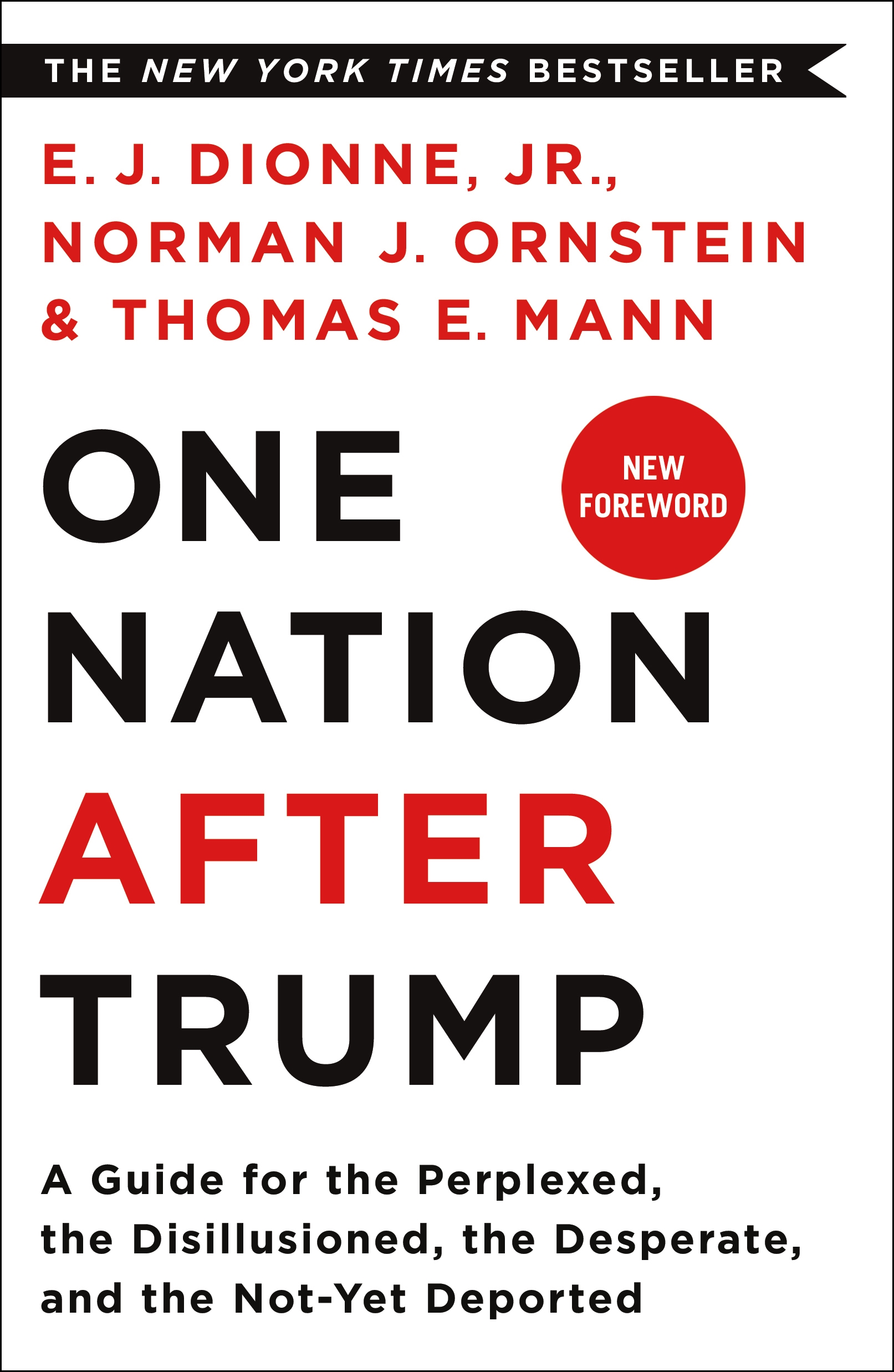
One Nation After Trump THE INSTANT NEW YORK TIMES AND WASHINGTON POST BESTSELLER A call to action from three of Washington's premier political scholar-journalists, One Nation After Trump offers the definitive work on the threat posed by the Trump presidency and how to counter it. American democracy was never supposed to give the nation a president like Donald Trump. We have never had a president who gave rise to such widespread alarm about his lack of commitment to the institutions of self-government, to the norms democracy requires, and to the need for basic knowledge about how government works. We have never had a president who raises profound questions about his basic competence and his psychological capacity to take on the most challenging political office in the world. Yet if Trump is both a threat to our democracy and a product of its weaknesses, the citizen activism he has inspired is the antidote. The reaction to the crisis created by Trump’s presidency can provide the foundation for an era of democratic renewal and vindicate our long experiment in self-rule. The award-winning authors of One Nation After Trump explain Trump’s rise and the danger his administration poses to our free institutions. They also offer encouragement to the millions of Americans now experiencing a new sense of citizenship and engagement and argue that our nation needs a unifying alternative to Trump’s dark and divisive brand of politics—an alternative rooted in a New Economy, a New Patriotism, a New Civil Society, and a New Democracy. One Nation After Trump is the essential book for our era, an unsparing assessment of the perils facing the United States and an inspiring roadmap for how we can reclaim the future. POLITICAL SCIENCE,American Government,National

Evaluating Media Bias Engaging and informative, Evaluating Media Bias provides an academically informed but broadly accessible overview of the major concepts and controversies involving media bias. Schiffer explores the contours of the partisan-bias controversy before pivoting to real biases: the patterns, constraints, and shortcomings plaguing American political news. POLITICAL SCIENCE,American Government,National

Health Justice Now "The best concise explanation of why the United States needs single-payer health care — and needs to widen the definition of health care itself."— The Washington Post Single payer healthcare is not complicated: the government pays for all care for all people. It’s cheaper than our current model, and most Americans (and their doctors) already want it. So what’s the deal with our current healthcare system, and why don’t we have something better? In Health Justice Now, Timothy Faust explains what single payer is, why we don’t yet have it, and how it can be won. He identifies the actors that have misled us for profit and political gain, dispels the myth that healthcare needs to be personally expensive, shows how we can smoothly transition to a new model, and reveals the slate of humane and progressive reforms that we can only achieve with single payer as the springboard. In this impassioned playbook, Faust inspires us to believe in a world where we could leave our job without losing healthcare for ourselves and our kids; where affordable housing is healthcare; and where social justice links arm-in-arm with health justice for us all. POLITICAL SCIENCE,American Government,National
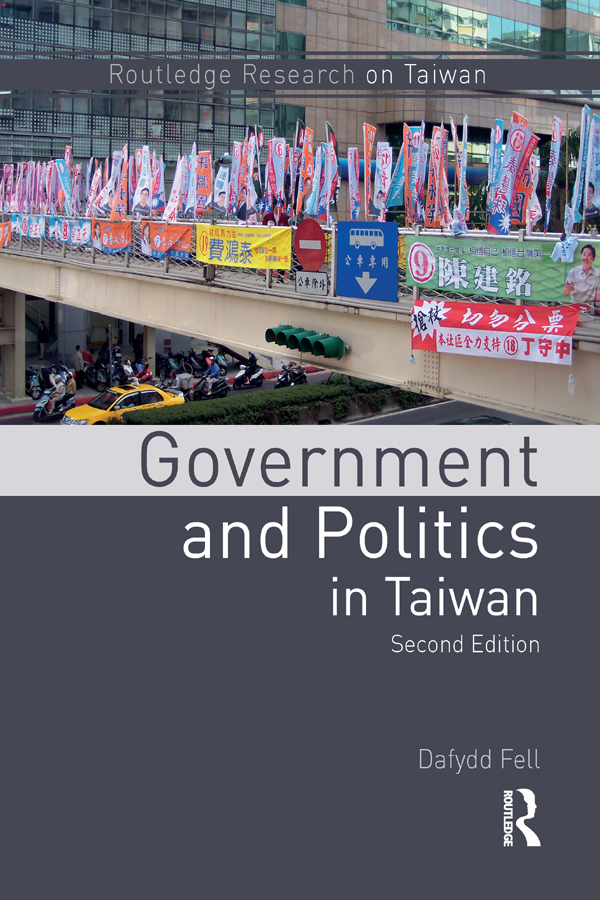
Government and Politics in Taiwan Written by an experienced teacher and scholar, this new and revised second edition of Government and Politics in Taiwan introduces students to the big questions concerning change and continuity in Taiwanese politics and governance. Taking a critical approach, Dafydd Fell provides students with the essential background to the history and development of the political system, as well as an explanation of the key structures, processes and institutions that have shaped Taiwan over the last few decades. Using key features such as suggestions for further reading and end-of-chapter study questions, this textbook covers: • the transition to democracy and party politics; • cross-Strait relations and foreign policy; • electoral politics and voting; • social movements; • national identity; • gender politics. Having been fully updated to take to take stock of the 2012 and 2016 General Elections, the Sunflower Movement and new developments in cross-Strait relations, this is an essential text for any course on Taiwanese politics, Chinese politics and East Asian politics. POLITICAL SCIENCE,American Government,National
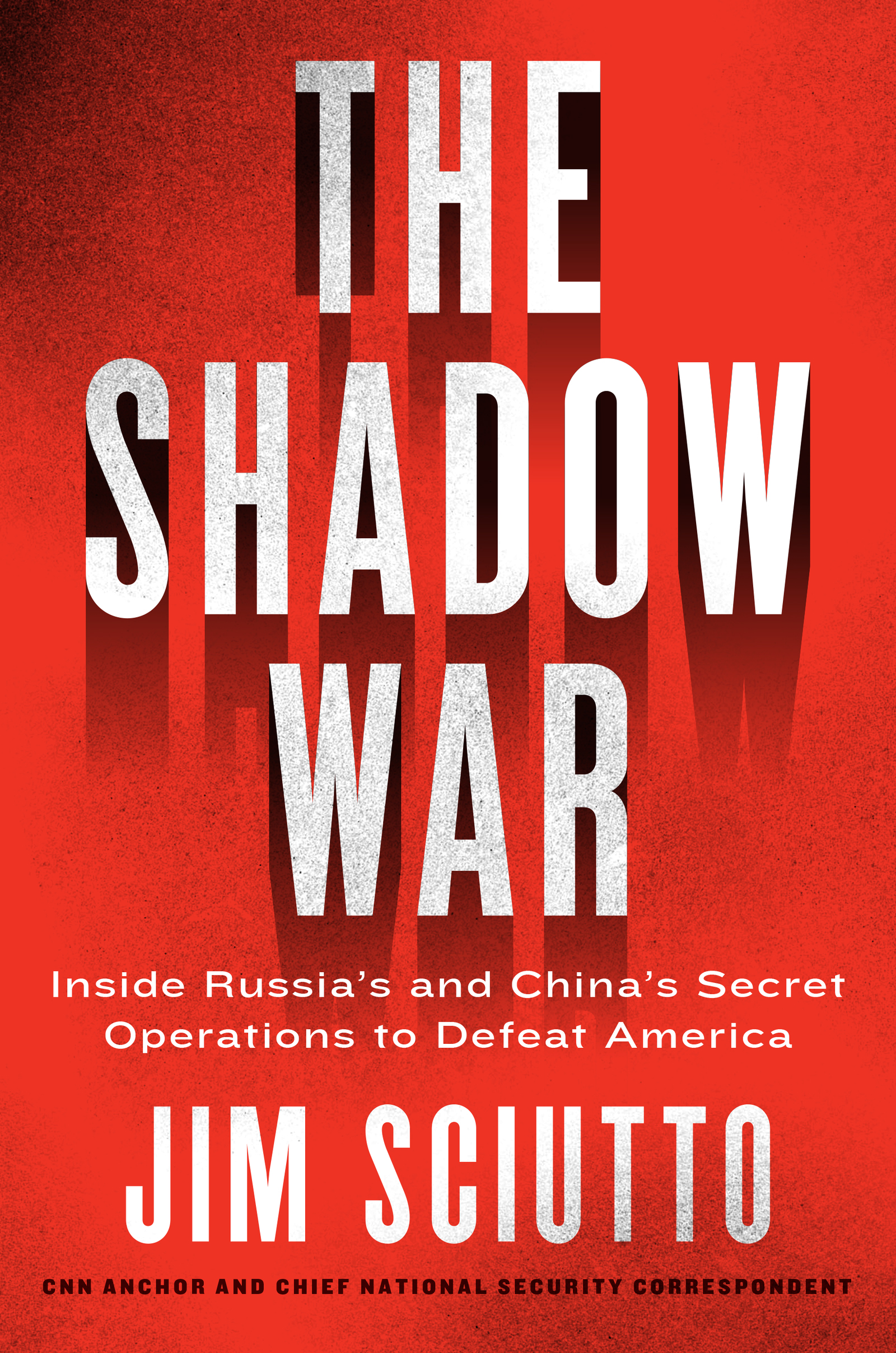
The Shadow War Are we losing a war few of us realize we’re fighting? Jim Sciutto, CNN’s Chief National Security Correspondent, reveals the invisible fronts that make up 21st century warfare, from disinformation campaigns to advanced satellite weapons. Poisoned dissidents. Election interference. Armed invasions. International treaties thrown into chaos. Secret military buildups. Hackers and viruses. Weapons deployed in space. China and Russia (and Iran and North Korea) spark news stories here by carrying out bold acts of aggression and violating international laws and norms. Isn’t this just bad actors acting badly? That kind of thinking is outdated and dangerous. Emboldened by their successes, these countries are, in fact, waging a brazen, global war on the US and the West. This is a new Cold War, which will not be won by those who fail to realize they are fighting it. The enemies of the West understand that while they are unlikely to win a shooting war, they have another path to victory. And what we see as our greatest strengths—open societies, military innovation, dominance of technology on Earth and in space, longstanding leadership in global institutions—these countries are undermining or turning into weaknesses. In The Shadow War, CNN anchor and chief national security correspondent Jim Sciutto provides us with a revealing and at times disturbing guide to this new international conflict. This Shadow War is already the greatest threat to America’s national security, even though most Americans know little or nothing about it. With on-the-ground reporting from Ukraine to the South China Sea, from a sub under the Arctic to unprecedented access to America’s Space Command, Sciutto draws on his deep knowledge, high-level contacts, and personal experience as a journalist and diplomat to paint the most comprehensive and vivid picture of a nation targeted by a new and disturbing brand of warfare. Thankfully, America is adapting and fighting back. In The Shadow War, Sciutto introduces readers to the dizzying array of soldiers, sailors, submariners and their commanders, space engineers, computer scientists, civilians, and senior intelligence officials who are on the front lines of this new kind of forever war. Intensive and disturbing, this invaluable and important work opens our eyes and makes clear that the war of the future is already here. POLITICAL SCIENCE,American Government,National

The War on Guns When it comes to the gun control debate, there are two kinds of data: data that's accurate, and data that left-wing billionaires, liberal politicians, and media want you to believe is accurate. In The War on Guns: Arming Yourself Against Gun Control Lies, nationally-renowned economist John R. Lott, Jr. turns a skeptical eye to well-funded anti-gun studies and stories that perpetuate false statistics to frighten Americans into giving up their guns. In this, his latest and most important book, The War on Guns , Lott offers the most thorough debunking yet of the so-called “facts,†“data,†and “arguments†of anti-gun advocates, exposing how they have repeatedly twisted or ignored the real evidence, the evidence that of course refutes them on every point. In The War on Guns , you’ll learn: Why gun licenses and background checks don’t stop crime How “gun-free†zones actually attract mass shooters Why Stand Your Ground laws are some of the best crime deterrents we have Women now hold over a quarter of concealed handgun permits How big-money liberal foundations and the federal government are pouring hundreds of millions of dollars into “public health†studies, the sole purpose of which is to manufacture false data against guns How media bias and ignorance skew the gun debate—and why it will get worse From 1950-2010, not a single mass public shooting occurred in an area where general civilians are allowed to carry guns POLITICAL SCIENCE,American Government,National
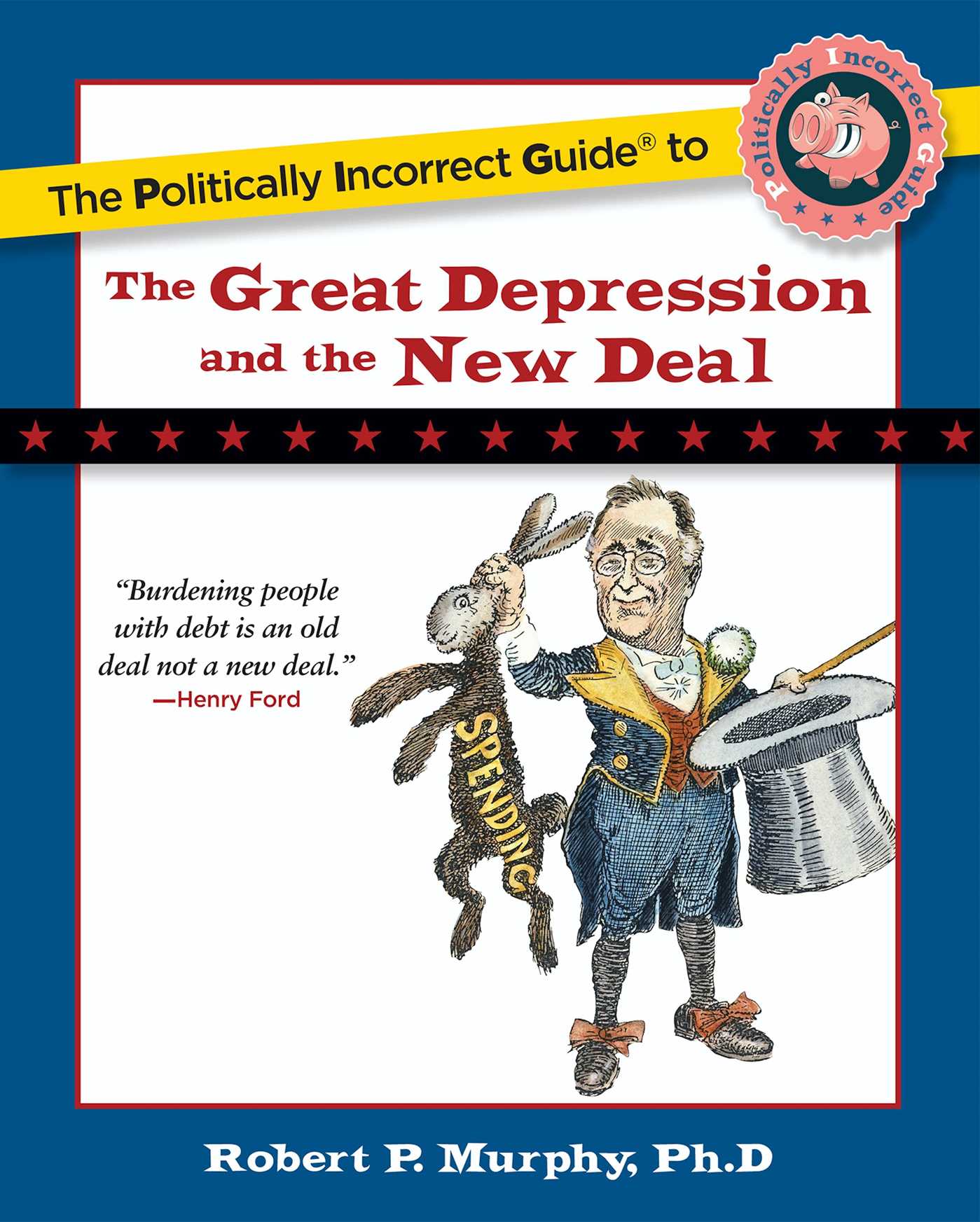
The Politically Incorrect Guide to the Great Depression and the New Deal In this timely new P.I. Guide, Murphy reveals the stark truth: free market failure didn't cause the Great Depression and the New Deal didn't cure it. Shattering myths and politically correct lies, he tells why World War II didn t help the economy or get us out of the Great Depression; why it took FDR to make the Depression Great; and why Herbert Hoover was more like Obama and less like Bush than the liberal media would have you believe. Free-market believers and capitalists everywhere should have this on their bookshelf and in their briefcases. POLITICAL SCIENCE,American Government,National

Adios, America A National Bestseller! Ann Coulter is back, more fearless than ever. In Adios, America she touches the third rail in American politics, attacking the immigration issue head-on and flying in the face of La Raza, the Democrats, a media determined to cover up immigrants' crimes, churches that get paid by the government for their "charity," and greedy Republican businessmen and campaign consultants—all of whom are profiting handsomely from mass immigration that’s tearing the country apart. Applying her trademark biting humor to the disaster that is U.S. immigration policy, Coulter proves that immigration is the most important issue facing America today. POLITICAL SCIENCE,American Government,National
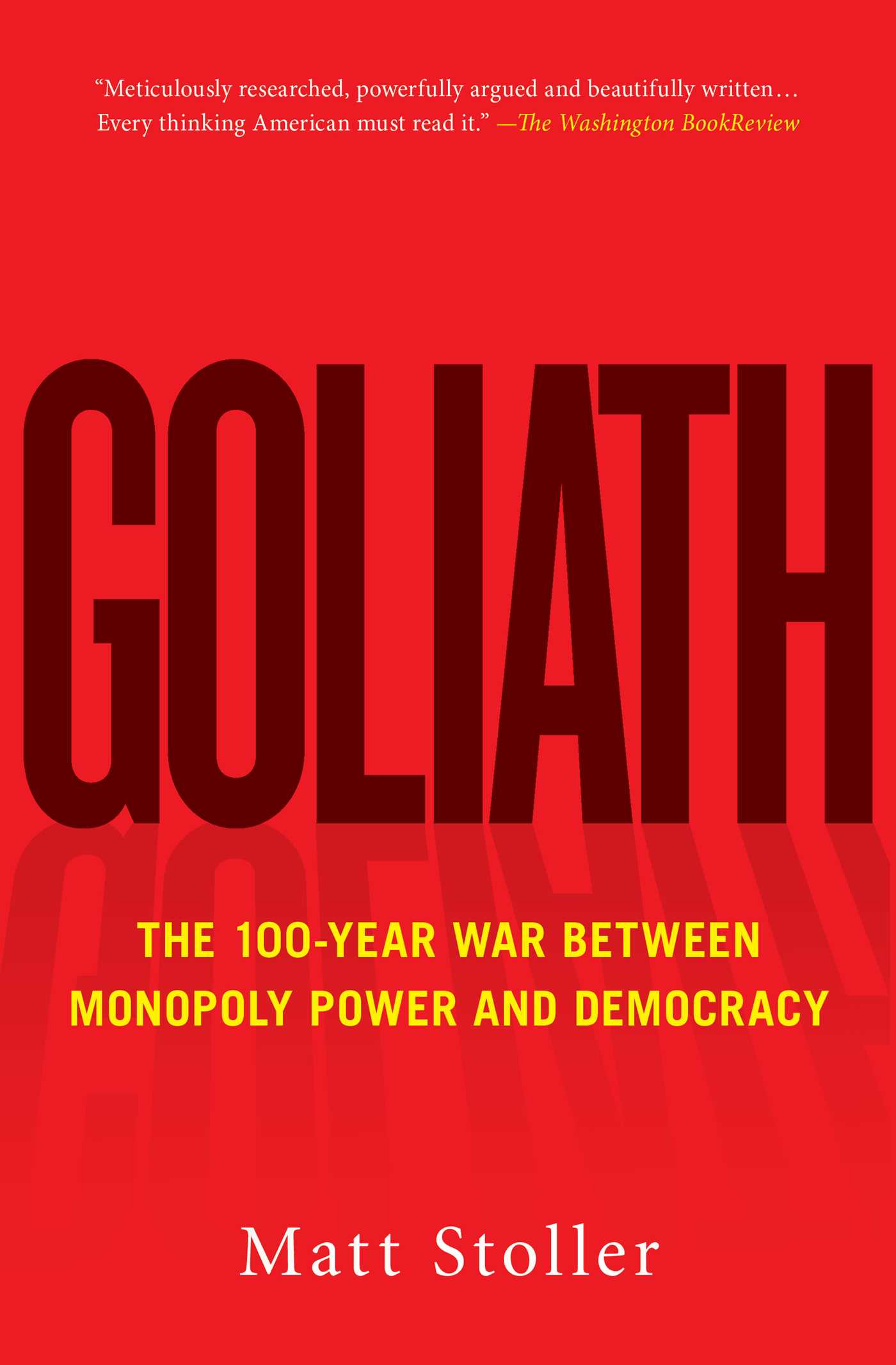
Goliath “Every thinking American must read†(The Washington Book Review) this startling and “insightful†(The New York Times) look at how concentrated financial power and consumerism has transformed American politics, and business. Going back to our country’s founding, Americans once had a coherent and clear understanding of political tyranny, one crafted by Thomas Jefferson and updated for the industrial age by Louis Brandeis. A concentration of power—whether by government or banks—was understood as autocratic and dangerous to individual liberty and democracy. In the 1930s, people observed that the Great Depression was caused by financial concentration in the hands of a few whose misuse of their power induced a financial collapse. They drew on this tradition to craft the New Deal. In Goliath, Matt Stoller explains how authoritarianism and populism have returned to American politics for the first time in eighty years, as the outcome of the 2016 election shook our faith in democratic institutions. It has brought to the fore dangerous forces that many modern Americans never even knew existed. Today’s bitter recriminations and panic represent more than just fear of the future, they reflect a basic confusion about what is happening and the historical backstory that brought us to this moment. The true effects of populism, a shrinking middle class, and concentrated financial wealth are only just beginning to manifest themselves under the current administrations. The lessons of Stoller’s study will only grow more relevant as time passes. “An engaging call to arms,†(Kirkus Reviews) Stoller illustrates here in rich detail how we arrived at this tenuous moment, and the steps we must take to create a new democracy. POLITICAL SCIENCE,American Government,National
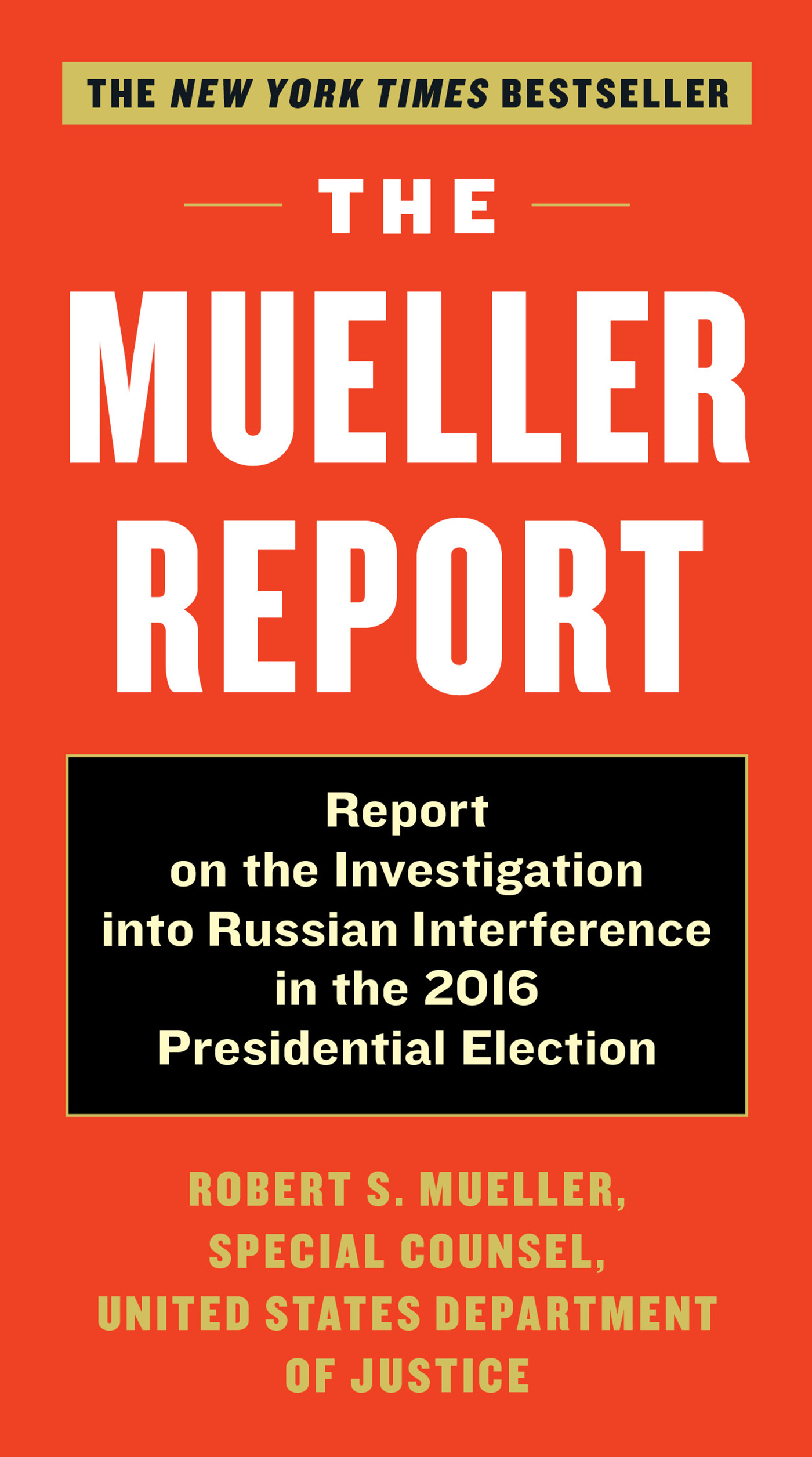
The Mueller Report Perhaps the most anticipated publication in American history, this is the full text, Volumes 1 and 2, of special counsel Robert Mueller's investigation. It is THE REPORT AND NOTHING BUT THE REPORT, in a beautifully typeset edition, with full searchability in ebook formats. It is, word for word, presented exactly as released by the Attorney General of the United States, with no positioning -- such as a celebrity introduction -- that would give it bias or impede its clarity. One of the most-talked-about investigations in American history, the subject of constant media discussion and speculation, non-stop and controversial attacks from the president, and the eager anticipation of a public wondering what the truth is, this long-awaited publication is an historic event. The Mueller Report continues Melville House's "tradition of publishing pivotal public documents."—The New York Times POLITICAL SCIENCE,American Government,National
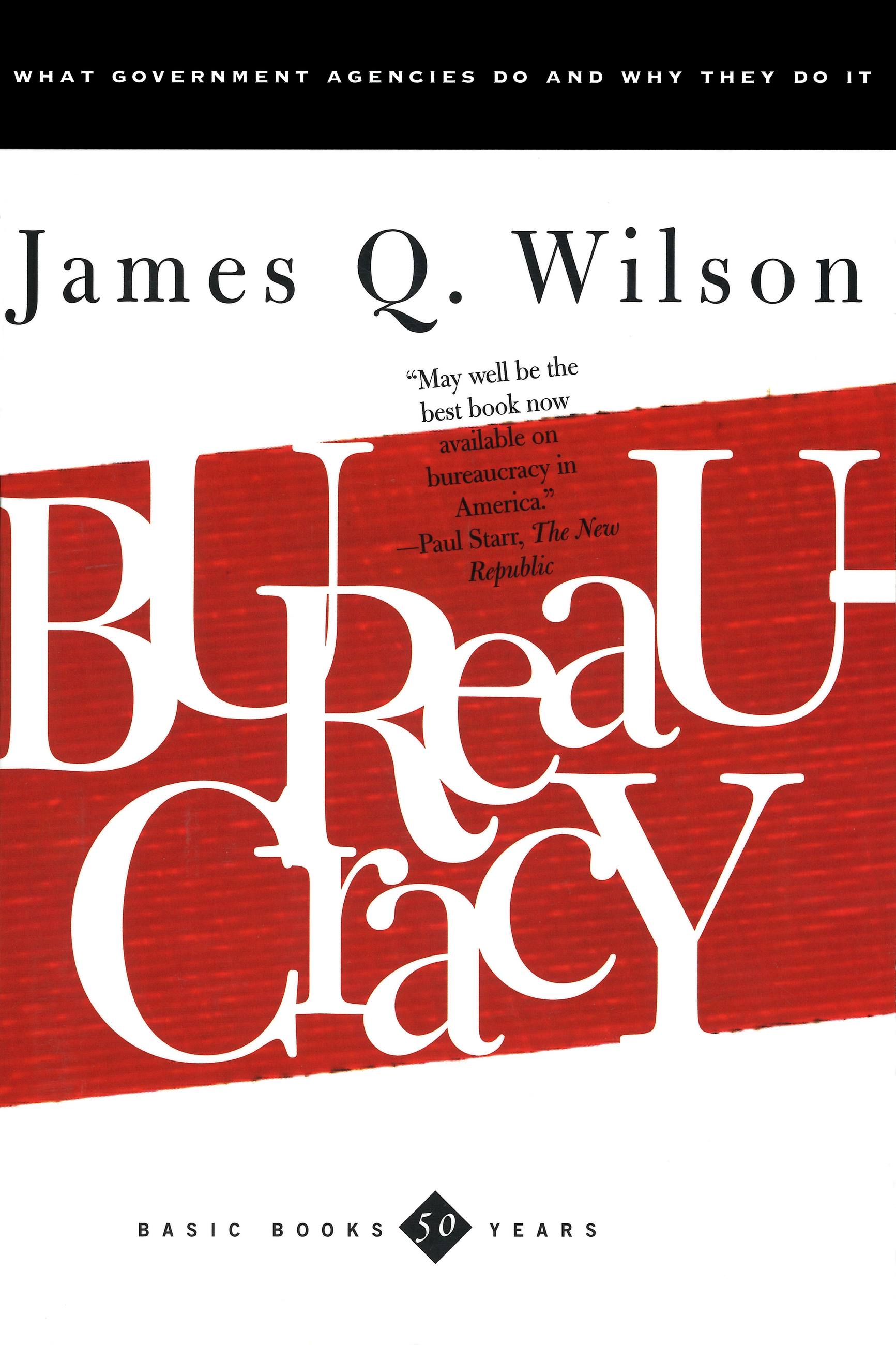
Bureaucracy The classic book on the way American government agencies work and how they can be made to work better -- the "masterwork" of political scientist James Q. Wilson (The Economist) In Bureaucracy, the distinguished scholar James Q. Wilson examines a wide range of bureaucracies, including the US Army, the FBI, the CIA, the FCC, and the Social Security Administration, providing the first comprehensive, in-depth analysis of what government agencies do, why they operate the way they do, and how they might become more responsible and effective. It is the essential guide to understanding how American government works. POLITICAL SCIENCE,American Government,National

Secret Empires #1 New York Times Bestseller! Peter Schweizer has been fighting corruption—and winning—for years. In Throw Them All Out, he exposed insider trading by members of Congress, leading to the passage of the STOCK Act. In Extortion, he uncovered how politicians use mafia-like tactics to enrich themselves. And in Clinton Cash, he revealed the Clintons’ massive money machine and sparked an FBI investigation. Now he explains how a new corruption has taken hold, involving larger sums of money than ever before. Stuffing tens of thousands of dollars into a freezer has morphed into multibillion-dollar equity deals done in the dark corners of the world. An American bank opening in China would be prohibited by US law from hiring a slew of family members of top Chinese politicians. However, a Chinese bank opening in America can hire anyone it wants. It can even invite the friends and families of American politicians to invest in can’t-lose deals. President Donald Trump’s children have made front pages across the world for their dicey transactions. However, the media has barely looked into questionable deals made by those close to Barack Obama, Joe Biden, John Kerry, Mitch McConnell, and lesser-known politicians who have been in the game longer. In many parts of the world, the children of powerful political figures go into business and profit handsomely, not necessarily because they are good at it, but because people want to curry favor with their influential parents. This is a relatively new phenomenon in the United States. But for relatives of some prominent political families, we may already be talking about hundreds of millions of dollars. Deeply researched and packed with shocking revelations, Secret Empires identifies public servants who cannot be trusted and provides a path toward a more accountable government. POLITICAL SCIENCE,American Government,National
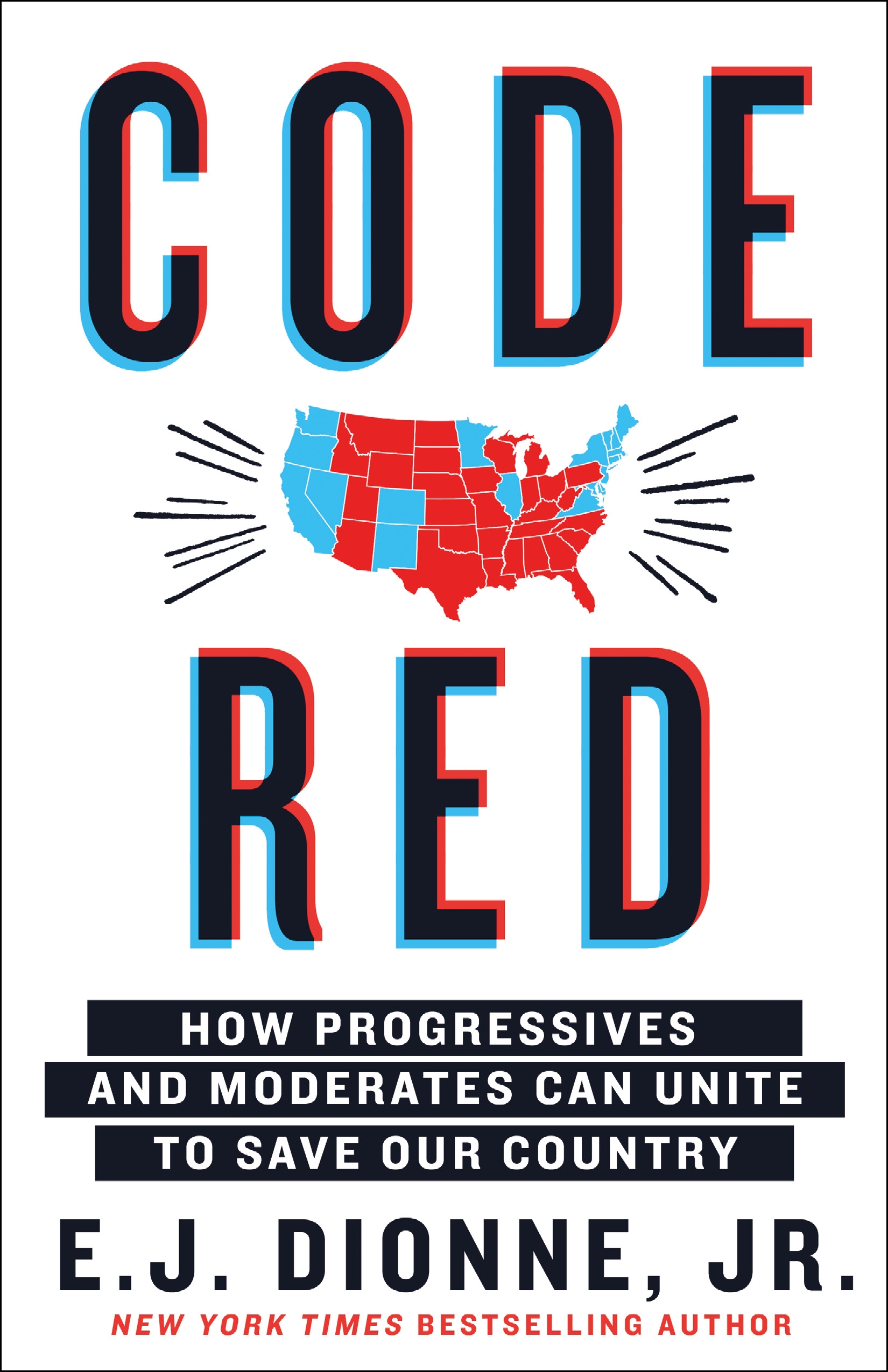
Code Red "An exquisitely timed book ... Code Red is a worthwhile exploration of the shared goals (and shared enemies) that unite moderates and progressives. But more than that, it is a sharp reminder that the common ground on which Dionne built his career has been badly eroded, with little prospect that it will soon be restored.†— The New York Times Book Review New York Times bestselling author and Washington Post columnist E. J. Dionne, Jr. sounds the alarm in Code Red, calling for an alliance between progressives and moderates to seize the moment and restore hope to America’s future for the 2020 presidential election. Will progressives and moderates feud while America burns? Or will these natural allies take advantage of the greatest opportunity since the New Deal Era to strengthen American democracy, foster social justice, and turn back the threats of the Trump Era? The United States stands at a crossroads. Broad and principled opposition to Donald Trump’s presidency has drawn millions of previously disengaged citizens to the public square and to the ballot boxes. This inspired and growing activism for social and political change hasn’t been seen since the days of Franklin Roosevelt’s New Deal policies and the Progressive and Civil Rights movements. But if progressives and moderates are unable—and unwilling—to overcome their differences, they could not only enable Trump to prevail again but also squander an occasion for launching a new era of reform. In Code Red, award-winning journalist E. J. Dionne, Jr., calls for a shared commitment to decency and a politics focused on freedom, fairness, and the future, encouraging progressives and moderates to explore common ground and expand the unity that brought about Democrat victories in the 2018 elections. He offers a unifying model for furthering progress with a Politics of Remedy, Dignity, and More: one that solves problems, resolve disputes, and moves forward; that sits at the heart of the demands for justice by both long-marginalized and recently-displaced groups; and that posits a positive future for Americans with more covered by health insurance, more with decent wages, more with good schools, more security from gun violence, more action to roll back climate change. Breaking through the partisan noise and cutting against conventional wisdom to provide a realistic look at political possibilities, Dionne offers a strategy for progressives and moderates to think more clearly and accept the responsibilities that history now imposes on them. Because at this point in our national story, change can’t wait. POLITICAL SCIENCE,American Government,National
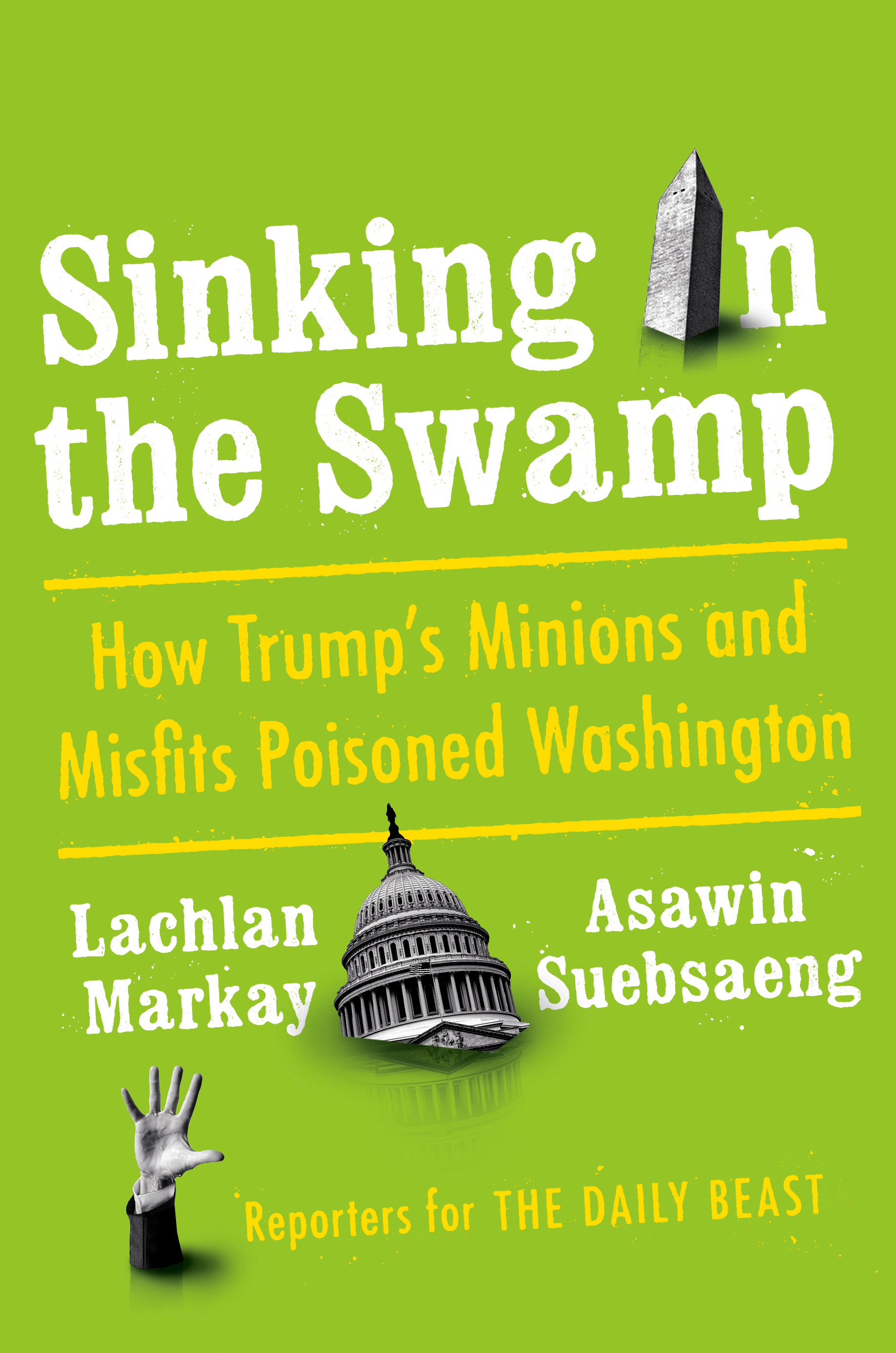
Sinking in the Swamp An eyewitness account of Donald Trump's clown car of lieutenants and lackeys who have polluted the corridors of power with their unprecedented awfulness. Two of Washington's most meddlesome reporters take readers on a deep dive into the murky underworld of President Trump's Washington, dishing the hilarious and frightening dirt on the charlatans, conspiracy theorists, ideologues, and run-of-the-mill con artists who have infected the highest echelons of American political power. For the past three years, reporting from the White House, the Trump hotel, and other dens of intrigue and influence, Lachlan Markay and Asawin Suebsaeng have revealed the sordid shenanigans of a rogue's gallery of Trumpworld incompetents and improbable A-listers -- earning them angry denunciations (or at least some vexed side-eye) from Trumpists such as the actor Jon Voight and Trump's former campaign czar and renowned obfuscator Corey Lewandowski as well as requisite threats of physical violence and ruin. Sinking in the Swamp will similarly pull no punches. Everyone from assorted Trump family members to Stephen Miller, Sean Hannity, and Diamond & Silk to Trumpworld's even more obscure accomplices will be plumbed, prodded, and exposed for their roles in the most shambolic moment in modern American political history. When they go low, Swin and Lachlan are right there with them, recorders running and notebooks at the ready. Sinking in the Swamp is an uncompromising account of the financial and moral degradation of our capital, told with righteous indignation and through the lens of key power players and foot soldiers whose own antics have often escaped the notice of the overworked press corps. As the 2020 election approaches, this page-turning, letting-it-all-hang-out narrative shows how the nation got to this nadir, tracing the story back to years before Trump's improbable run for the White House and cataloguing the stomach-turning moments that followed. POLITICAL SCIENCE,American Government,National
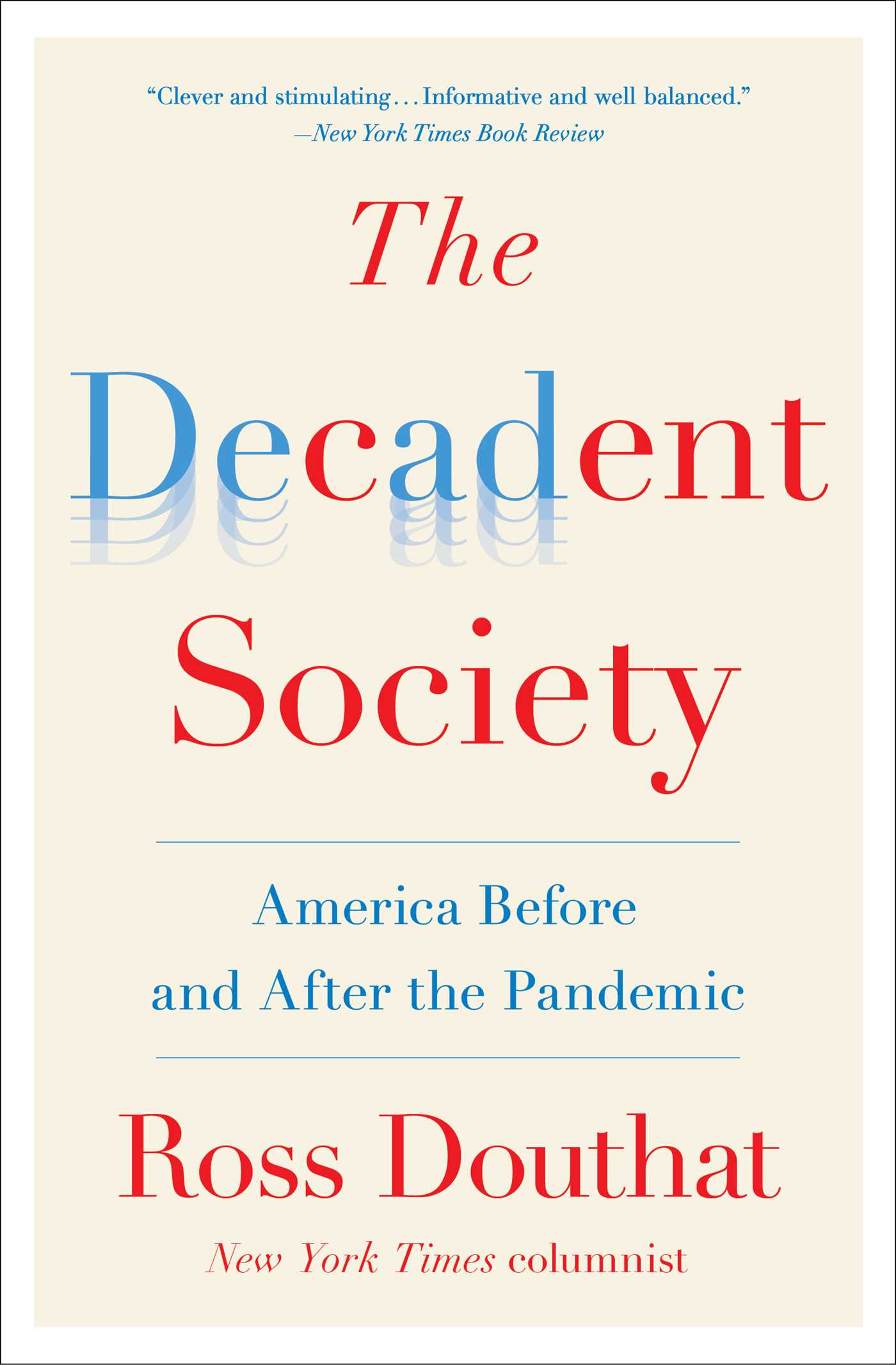
The Decadent Society From the New York Times columnist and bestselling author of Bad Religion, a powerful portrait of how our turbulent age is defined by dark forces seemingly beyond our control Today the Western world seems to be in crisis. But beneath our social media frenzy and reality television politics, the deeper reality is one of drift, repetition, and dead ends. The Decadent Society explains what happens when a rich and powerful society ceases advancing—how the combination of wealth and technological proficiency with economic stagnation, political stalemates, cultural exhaustion, and demographic decline creates a strange kind of “sustainable decadence,†a civilizational languor that could endure for longer than we think. Ranging from our grounded space shuttles to our Silicon Valley villains, from our blandly recycled film and television—a new Star Wars saga, another Star Trek series, the fifth Terminator sequel—to the escapism we’re furiously chasing through drug use and virtual reality, Ross Douthat argues that many of today’s discontents and derangements reflect a sense of futility and disappointment—a feeling that the future was not what was promised, that the frontiers have all been closed, and that the paths forward lead only to the grave. In this environment we fear catastrophe, but in a certain way we also pine for it—because the alternative is to accept that we are permanently decadent: aging, comfortable and stuck, cut off from the past and no longer confident in the future, spurning both memory and ambition while we wait for some saving innovation or revelations, growing old unhappily together in the glowing light of tiny screens. Correcting both optimists who insist that we’re just growing richer and happier with every passing year and pessimists who expect collapse any moment, Douthat provides an enlightening diagnosis of the modern condition—how we got here, how long our age of frustration might last, and how, whether in renaissance or catastrophe, our decadence might ultimately end. POLITICAL SCIENCE,American Government,National

Defend the Border and Save Lives Former ICE Director Tom Homan has been at the forefront of the conservative fight to secure our borders and offers proof that illegal immigration is not a victimless crime. Illegal immigration is the most controversial and emotional issue this country faces today. President Trump was elected on his promise to fix illegal immigration and build a wall on our southern border. Because he won on this issue, the Democrats refuse to work with him, and we experienced a government shutdown as a result of this divide. The Democrats have supported funding in the past and, in his State of the Union, the President said that he wants to unify and work together to resolve this and all the other challenges facing America. The Democrats sat on their hands. They won't budge. Clearly, as a party, they don't care about the facts, only about denying whatever success they can to this president. Former ICE Director and Fox News contributor Tom Homan knows the facts. He's spent his life on the border and knows that if we don't control illegal immigration now, this country will continue to suffer the consequences of crime, drugs, and financial strain - and it will get much much worse. In Defend the Border and Save Lives, Homan shares what illegal immigration is really about. Illegal immigration should not be a partisan issue. Now is the time to fix this issue that has claimed so many victims and divided this country. We need to pull the curtain back and expose what truly happens and separate facts from fiction. Illegal immigration is not a victimless crime, and the victims are the illegals and their innocent children as well as the Americans who suffer at the hand of the criminals who sneak into this country. POLITICAL SCIENCE,American Government,National

American Government, Second Edition This exciting new book explores the role of government, politics, and policy in American lives. Full of real life applications and scenarios, this text encourages and enables political thinking. The second edition has been updated to include recent developments in U.S. politics and government. This includes the description and analysis of the 2016 elections as well as the early Trump administration. Chapters have expanded coverage of immigration policy, environmental policy, economic policy, and global affairs (including counterterrorism policy). The text also includes analysis of racial issues in contemporary American politics and law. It also addresses questions about the state of the economy, jobs, and wages. Hyperlinks and URLs provide "deeper dives" into various topics and examples of comparative politics. POLITICAL SCIENCE,American Government,National

OMG WTF Does the Constitution Actually Say? Do you know what the Constitution ACTUALLY says? This witty and highly relevant annotation of our founding document is the go-to guide to how our government really works (or is supposed to work). Written by political savant and entertainment veteran, Ben Sheehan, and vetted for accuracy by experts in the field of constitutional law, OMG WTF Does the Constitution Actually Say? is an entertaining and accessible guide that explains what the Constitution actually lays out. With clear notes and graphics on everything from presidential powers to Supreme Court nominations to hidden loopholes, Sheehan walks us through the entire Constitution from its preamble to its final amendment (with a bonus section on the Declaration of Independence). Besides putting the Constitution in modern-day English so that it can be understood, OMG WTF Does the Constitution Actually Say? gives readers all of the info they need to be effective voters and citizens in the November elections and beyond. p.p1 {margin: 0.0px 0.0px 0.0px 0.0px; font: 14.0px Calibri} p.p2 {margin: 0.0px 0.0px 0.0px 0.0px; font: 14.0px Calibri; min-height: 17.0px} p.p1 {margin: 0.0px 0.0px 0.0px 0.0px; font: 14.0px Calibri} p.p1 {margin: 0.0px 0.0px 0.0px 0.0px; font: 14.0px Calibri} p.p1 {margin: 0.0px 0.0px 0.0px 0.0px; font: 14.0px Calibri} p.p2 {margin: 0.0px 0.0px 0.0px 0.0px; font: 14.0px Calibri; min-height: 17.0px} POLITICAL SCIENCE,American Government,National
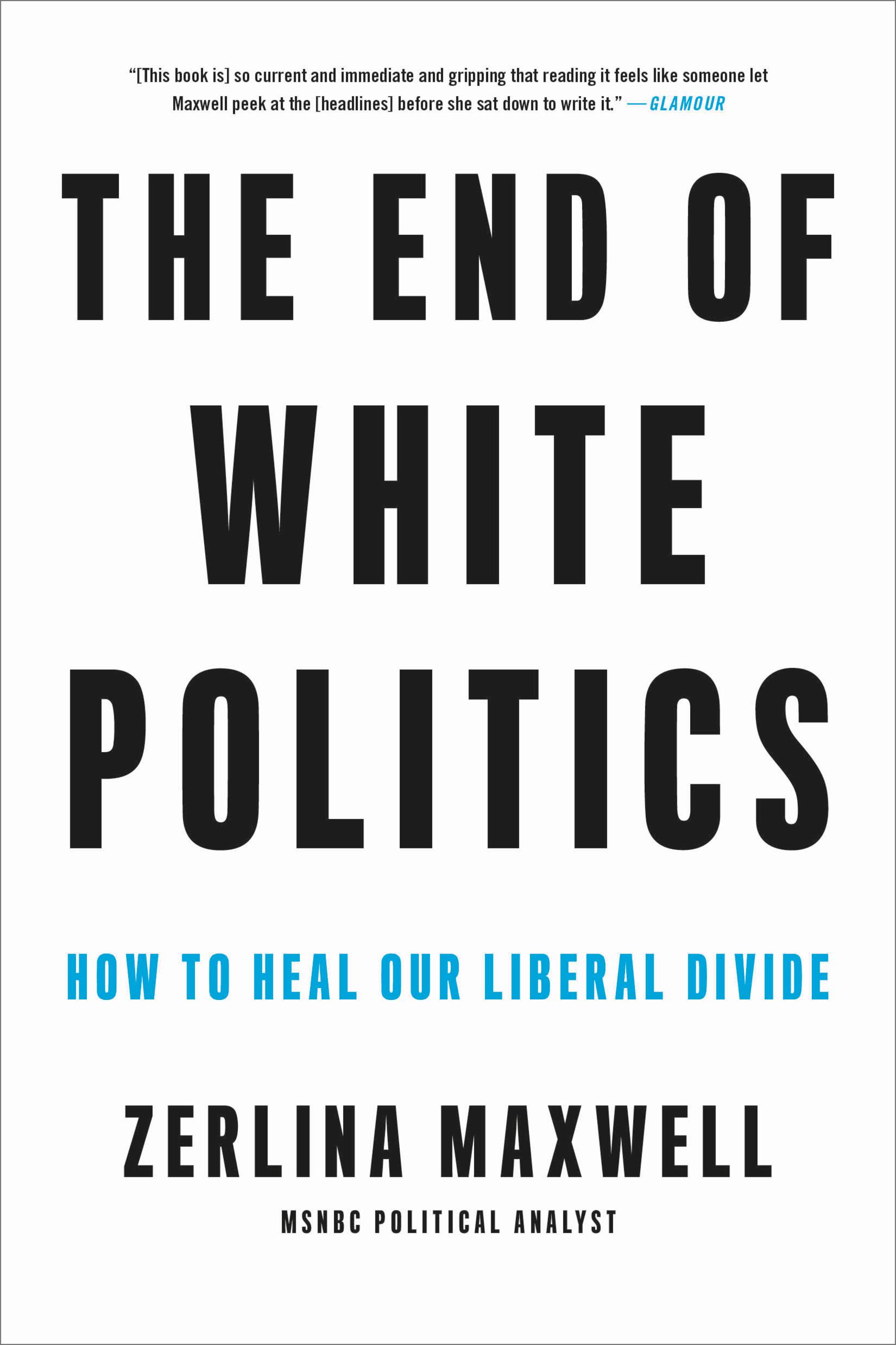
The End of White Politics In the entire history of the United States of America, we've never elected a woman as our president. And we've only had one president who was not a white man. After working on two presidential campaigns (for Barack Obama and Hillary Clinton), MSNBC political analyst and SiriusXM host Zerlina Maxwell gained first-hand knowledge of everything liberals have been doing right over the past few elections-and everything they are still doing wrong. Ultimately, these errors worked in President Donald Trump's favor in 2016; he effectively ran a campaign on white identity politics, successfully tapping into white male angst and resistance. In 2020, after the Democratic Party's most historically diverse pool of presidential candidates finally dwindled down to Joe Biden, once again an older white man, Maxwell has posed the ultimate question: what now, liberals? Fueled by Maxwell's trademark wit and candor, The End of White Politics dismantles the past and present problems of the Left, challenging everyone from scrappy, young "Bernie Bros" to seasoned power players in the "Billionaire Boys' Club." No topic is taboo; whether tackling the white privilege that enabled Mayor Pete Buttigieg's presidential run, the controversial #HashtagActivism of the Millennial generation, the massive individual donations that sway politicians toward maintaining the status quo of income inequality, or the lingering racism that debilitated some Democratic presidential contenders and cut their promising campaigns short, Maxwell pulls no punches in her fierce critique. However, underlying all of these individual issues, Maxwell argues that it's the "liberal-minded" party's struggle to engage women and communities of color-and its preoccupation with catering to the white, male working class-that threatens to be its most lethal shortfall. The times-and the demographics-are changing, and in order for progressive politics to prevail, we must acknowledge our shortcomings, take ownership of our flaws, and do everything in our power to level the playing field for all Americans. The End of White Politics shows exactly how and why progressives can lean into identity politics, empowering marginalized groups, and uniting under a common vision that will benefit us all. POLITICAL SCIENCE,American Government,National
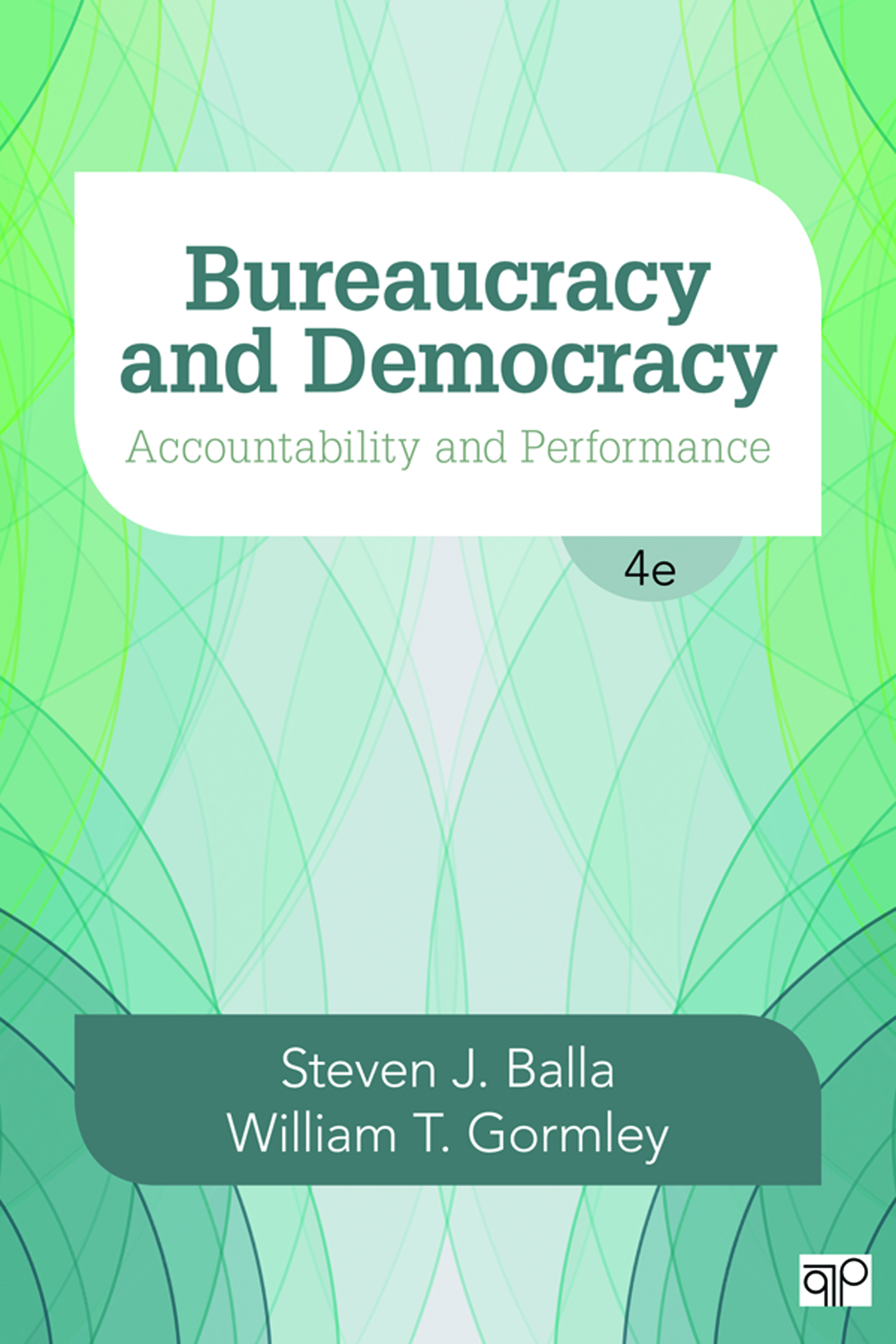
Bureaucracy and Democracy Given the influence of public bureaucracies in policymaking and implementation, Steven J. Balla and William T. Gormley assess their performance using four key perspectives—bounded rationality, principal-agent theory, interest group mobilization, and network theory—to help students develop an analytic framework for evaluating bureaucratic accountability. The new Fourth Edition of Bureaucracy and Democracy: Accountability and Performance provides a thorough review of bureaucracy during the Obama and Trump administrations, as well as new attention to state and local level examples and the role of bureaucratic values.? New to this Edition: Interviews with two new cabinet secretaries—Christine Todd Whitman and Tom Ridge—with insightful quotes from them throughout the book. Added material on the battle over regulations, a battle that will loom large during the Trump administration, including midnight regulations and the Congressional Review Act. New examples demonstrate the activity and influence of constituencies of different kinds including the placing of women and minorities on US currency, a vignette that features the musical Hamilton, and the political protests surrounding the Dakota Access and Keystone XL pipelines. A new discussion of the privatization of roads, the pros and cons. POLITICAL SCIENCE,American Government,National
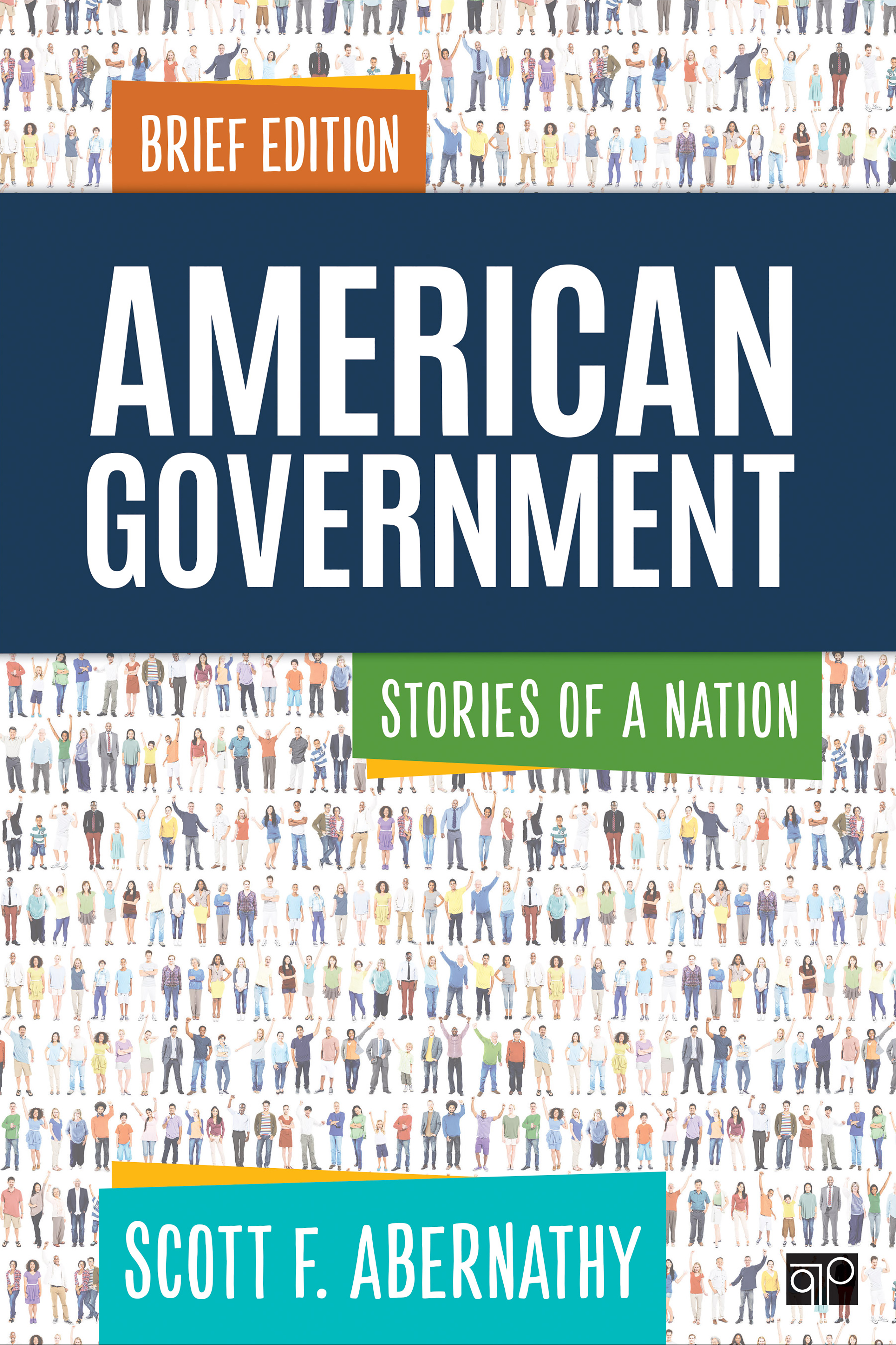
American Government American government is not just one story—it’s many stories. Our stories. And they are still being told. In American Government: Stories of a Nation , author Scott Abernathy tunes in to the voices of America’s people, showing how diverse ideas throughout our nation’s history have shaped our political institutions, our identities, the way we participate and behave, the laws we live by, and the challenges we face. His storytelling approach brings the core concepts of government to life, making them meaningful and memorable, and allowing all students to see themselves reflected in the pages. For the new Brief Edition, Abernathy has carefully condensed and updated the content from the Full version, giving you the information you need--and the stories you can relate to--in a more concise, value-oriented package. POLITICAL SCIENCE,American Government,National
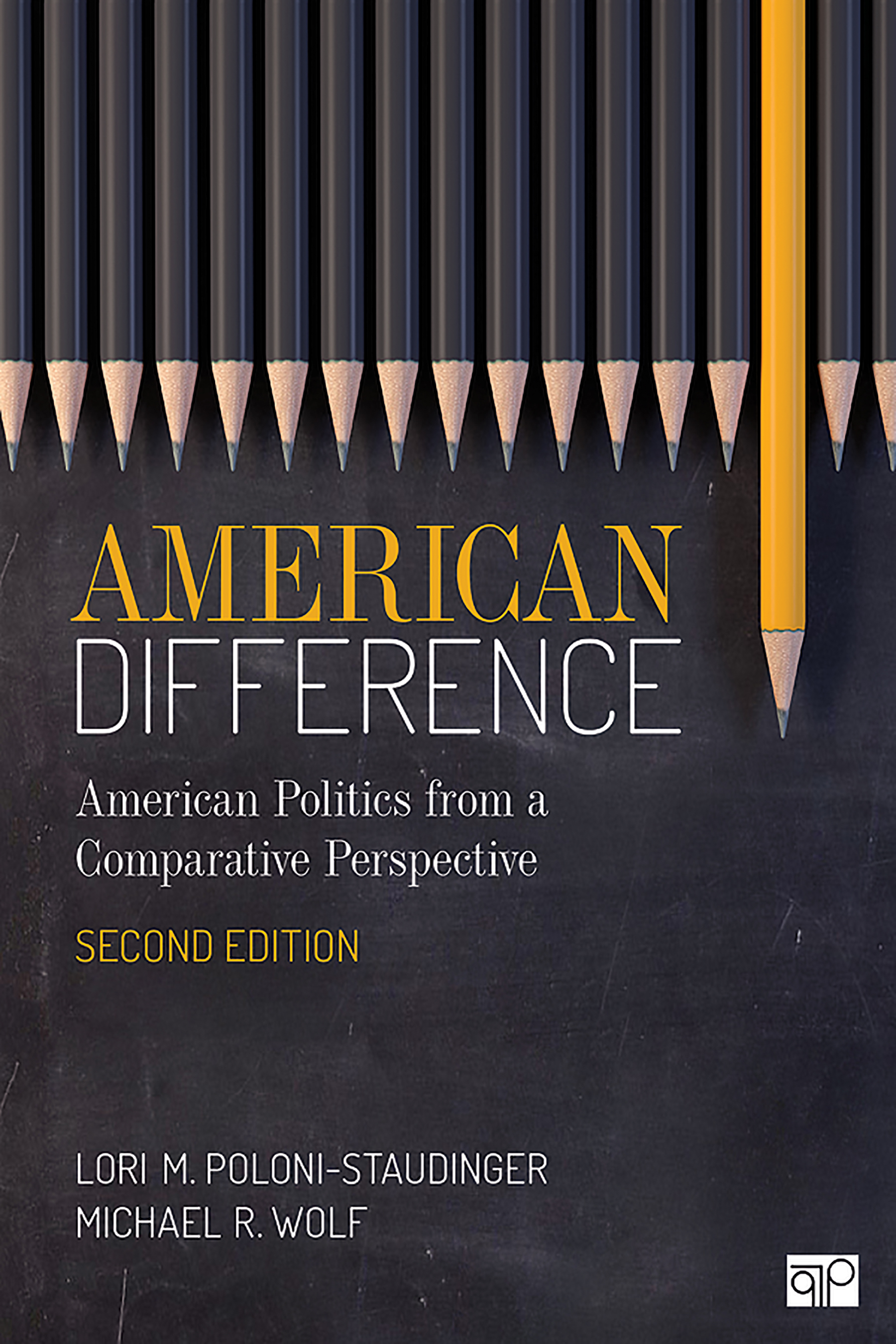
American Difference Examining democracies from a comparative perspective helps us better understand why politics—or, as Harold Lasswell famously said, “who gets what, when, and howâ€â€”differ among democracies. American Difference: A Guide to American Politics in Comparative Perspective takes you through different aspects of democracy—political culture, institutions, interest groups, political parties, and elections—and, unlike other works, explores how the United States is both different from and similar to other democracies. The fully updated Second Edition has been expanded to include several new chapters and discussion on civil liberties and civil rights, constitutional arrangements, elections and electoral institutions, and electoral behavior. This edition also includes data around the 2016 general election and 2018 midterm election POLITICAL SCIENCE,American Government,National

White House Inc. An in-depth investigation into Donald Trump’s business—and how he used America’s top job to service it. White House, Inc. is a newsmaking exposé that details President Trump’s efforts to make money off of politics, taking us inside his exclusive clubs, luxury hotels, overseas partnerships, commercial properties, and personal mansions. Alexander tracks hundreds of millions of dollars flowing freely between big businesses and President Trump. He explains, in plain language, how Trump tried to translate power into profit, from the 2016 campaign to the ramp-up to the 2020 campaign. Just because you turn the presidency into a business doesn’t necessarily mean you turn it into a good business. After Trump won the White House, profits plunged at certain properties, like the Doral golf resort in Miami. But the presidency also opened up new opportunities. Trump’s commercial and residential property portfolio morphed into a one-of-a-kind marketplace, through which anyone, anywhere, could pay the president of the United States. Hundreds of customers—including foreign governments, big businesses, and individual investors—obliged. The president's disregard for norms sparked a trickle-down ethics crisis with no precedent in modern American history. Trump appointed an inner circle of centimillionaires and billionaires—including Ivanka Trump, Jared Kushner, Wilbur Ross, and Carl Icahn—who came with their own conflict-ridden portfolios. Following the president’s lead, they trampled barriers meant to separate their financial holdings from their government roles. White House, Inc. is a page-turning, hair-raising investigation into Trump and his team, who corrupted the U.S. presidency and managed to avoid accountability. Until now. POLITICAL SCIENCE,American Government,National
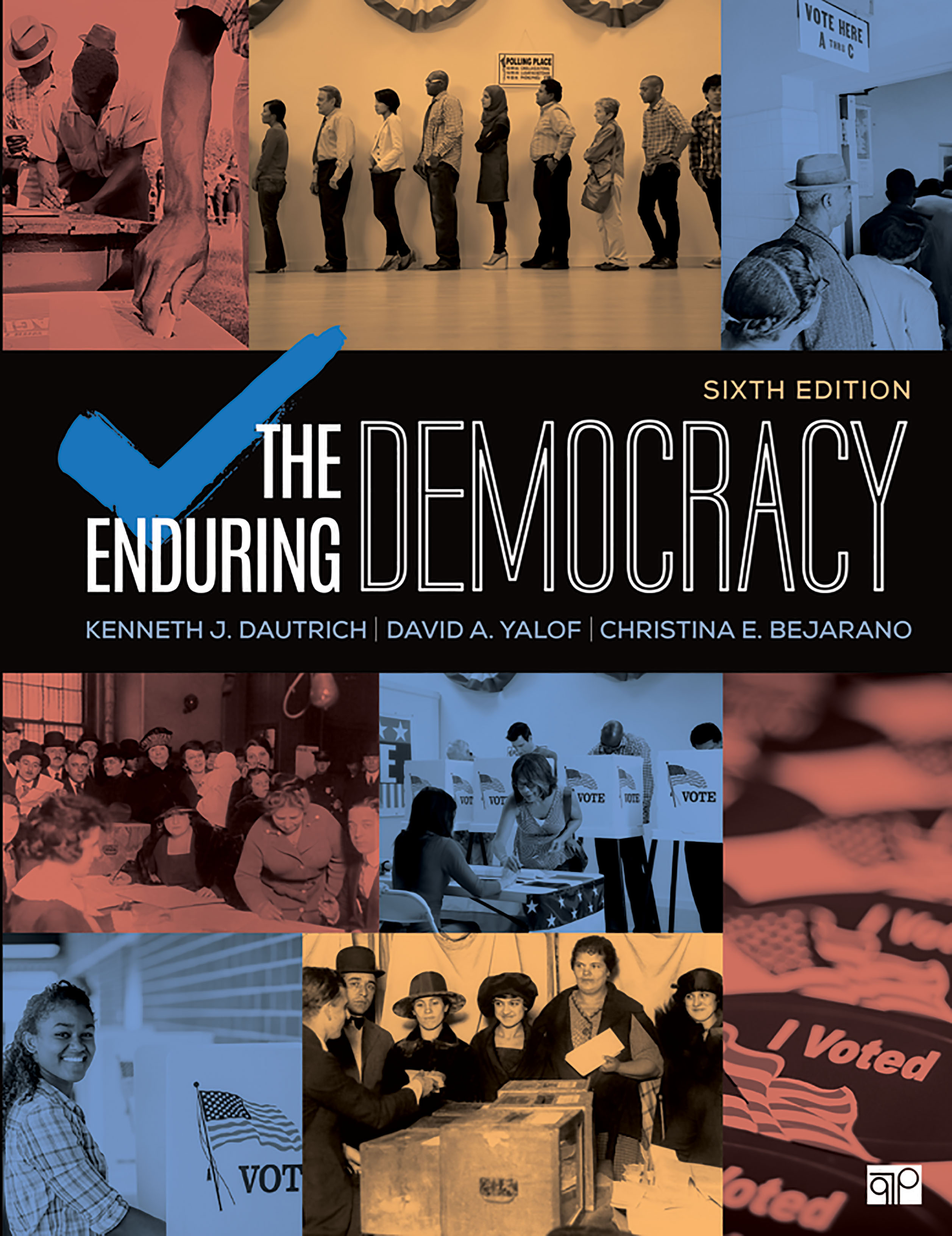
The Enduring Democracy The Enduring Democracy by Kenneth Dautrich, David A. Yalof, and Christina Bejarano examines the current state of American politics through the lenses of American history and the nation’s changing demographics. This two-pronged approach encourages students to place current issues and controversies into historical perspective, and to think critically about how those issues and controversies are impacted by America’s increasingly diverse population. By analyzing and understanding the influences of historical context and demographics, students can debate effectively with references, use historical outcomes to predict for the future, and create strong arguments based on what they know about fundamental changes in the political landscape. The highly anticipated Sixth Edition frames the 2016 general election and 2018 midterm elections from the perspective of what they mean to college students, so that they can see the relevance of American government in their daily lives. Also available as a digital option (courseware). Learn more about The Enduring Democracy, Sixth Edition - Vantage Digital Option. POLITICAL SCIENCE,American Government,National

¿Qu¿ diablos dice realmente la Constitucion? [OMG WTF Does the Constitution Actually Say?] Do you know what the Constitution ACTUALLY says? This witty and highly relevant annotation of our founding document is the go-to guide to how our government really works (or is supposed to work). Written by political savant and entertainment veteran, Ben Sheehan, and vetted for accuracy by experts in the field of constitutional law, OMG WTF Does the Constitution Actually Say? is an entertaining and accessible guide that explains what the Constitution actually lays out. With clear notes and graphics on everything from presidential powers to Supreme Court nominations to hidden loopholes, Sheehan walks us through the entire Constitution from its preamble to its final amendment (with a bonus section on the Declaration of Independence). Besides putting the Constitution in modern-day English so that it can be understood, OMG WTF Does the Constitution Actually Say? gives readers all of the info they need to be effective voters and citizens in the November elections and beyond. p.p1 {margin: 0.0px 0.0px 0.0px 0.0px; font: 14.0px Calibri} p.p2 {margin: 0.0px 0.0px 0.0px 0.0px; font: 14.0px Calibri; min-height: 17.0px} p.p1 {margin: 0.0px 0.0px 0.0px 0.0px; font: 14.0px Calibri} p.p1 {margin: 0.0px 0.0px 0.0px 0.0px; font: 14.0px Calibri} p.p1 {margin: 0.0px 0.0px 0.0px 0.0px; font: 14.0px Calibri} p.p2 {margin: 0.0px 0.0px 0.0px 0.0px; font: 14.0px Calibri; min-height: 17.0px} POLITICAL SCIENCE,American Government,National
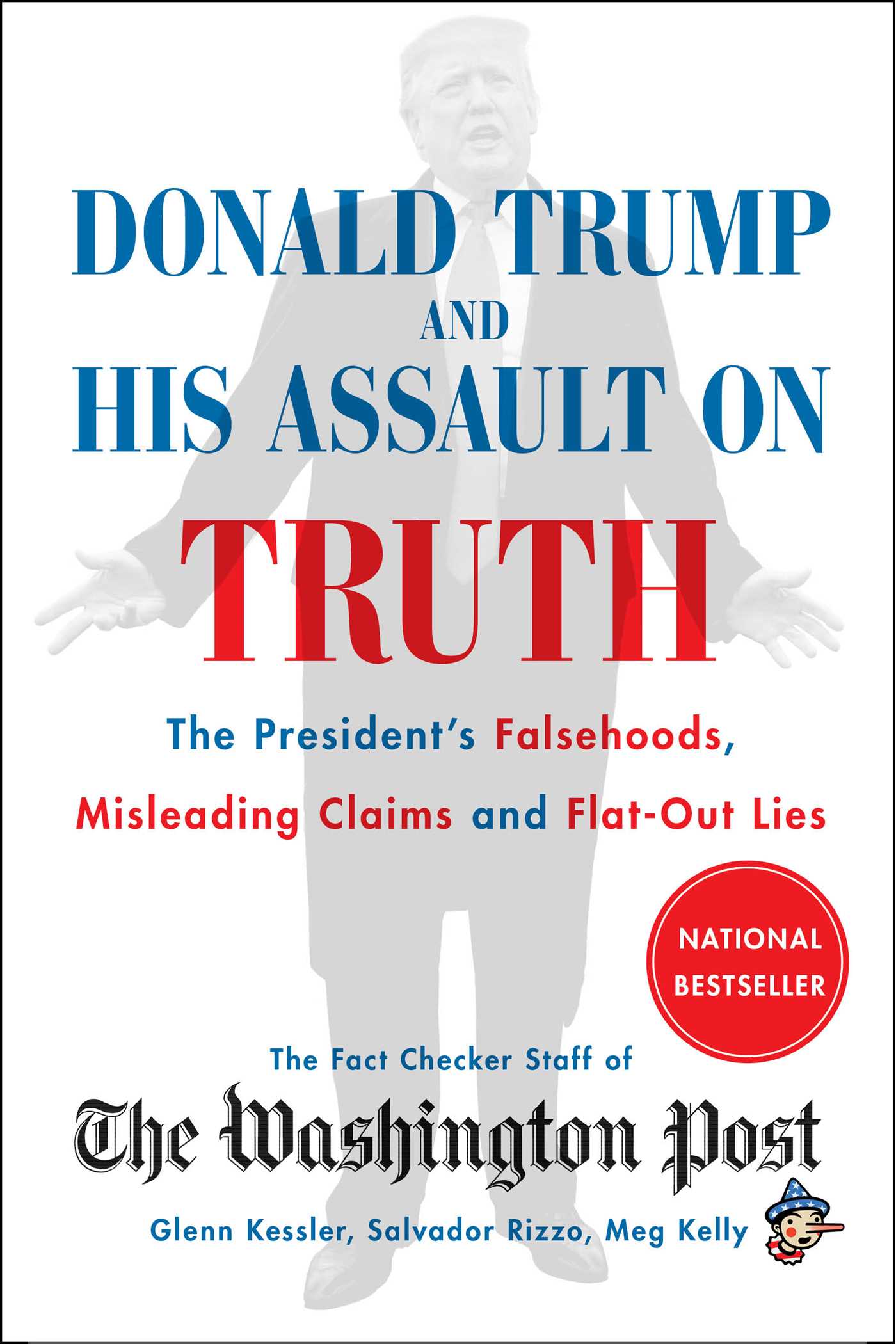
Donald Trump and His Assault on Truth A NATIONAL BESTSELLER In perilous times, facts, expertise, and truth are indispensable. President Trump’s flagrant disregard for the truth and his self-aggrandizing exaggerations, specious misstatements, and bald-faced lies have been rigorously documented and debunked since the first day of his presidency by The Washington Post’s Fact Checker staff. Donald Trump and His Assault on Truth is based on the only comprehensive compilation and analysis of the more than 16,000 fallacious statements that Trump has uttered since the day of his inauguration. He has repeated many of his most outrageous claims dozens or even hundreds of times as he has sought to bend reality to his political fantasy and personal whim. Drawing on Trump’s tweets, press conferences, political rallies, and TV appearances, The Washington Post identifies his most frequently used misstatements, biggest whoppers, and most dangerous deceptions. This book unpacks his errant statements about the economy, immigration, the impeachment hearings, foreign policy, and, of critical concern now, the coronavirus crisis as it unfolded. Fascinating, startling, and even grimly funny, Donald Trump and His Assault on Truth by The Washington Post is the essential, authoritative record of Trump’s shocking disregard for facts. POLITICAL SCIENCE,American Government,National
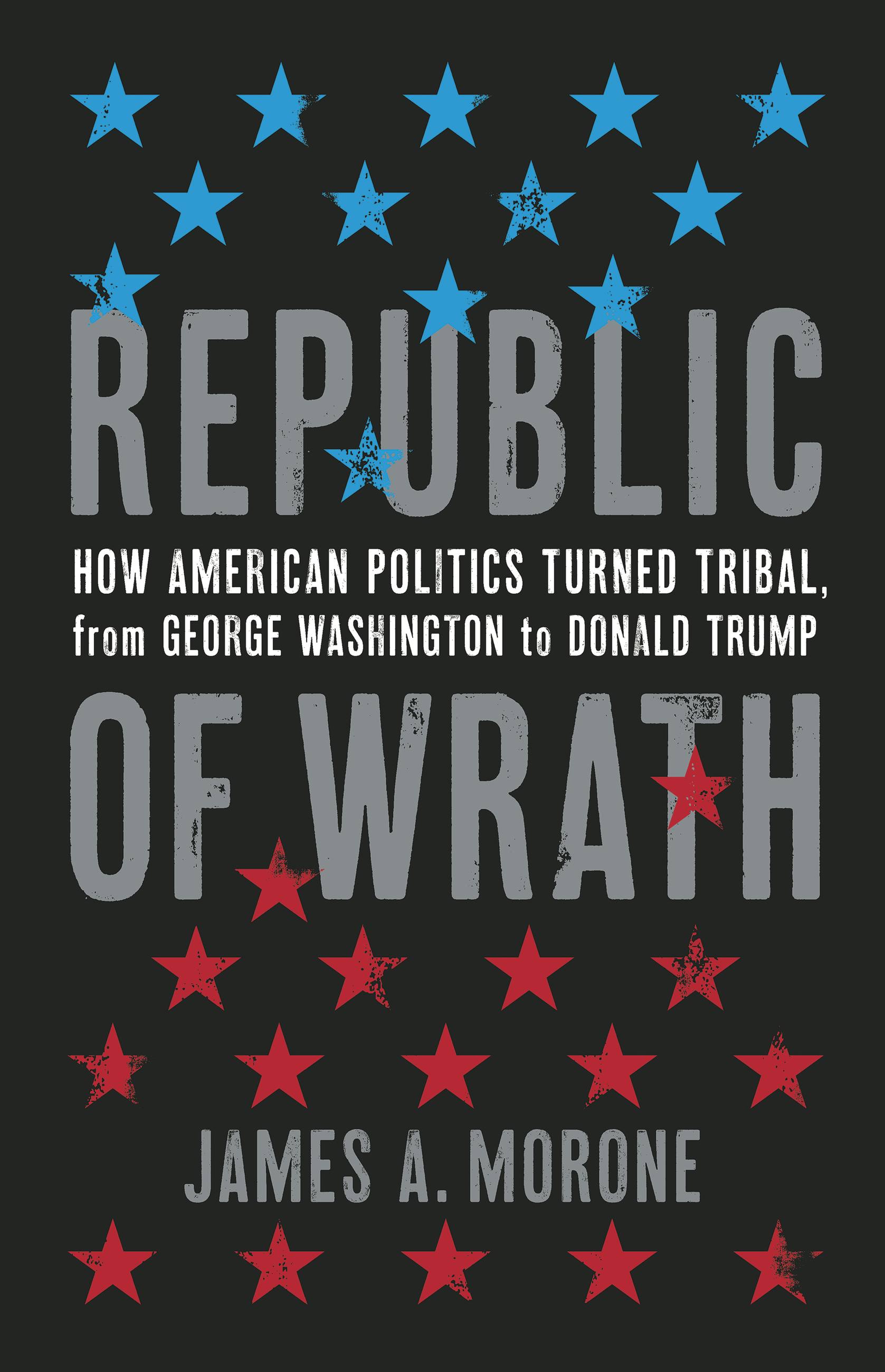
Republic of Wrath A prize-winning political scientist untangles the deep roots of tribalism in America. American politics seems to be in an unprecedented uproar. But in this revelatory work of political history, James A. Morone shows that today's rancor isn't what's new -- the clarity of the battle lines is. Past eras were full of discord, but the most contentious question in American society -- Who are we? -- never split along party lines. Instead, each party reached out to different groups on the margins of power: immigrants, African Americans, and women. But, as the United States underwent profound societal transformations from the Civil War to the populist explosion to the Great Migration to civil rights to the latest era of immigration, the party alignment shifted. African Americans conquered the old segregationist party and Democrats slowly evolved into the party of civil rights, immigration, and gender rights. Republicans turned whiter and more nativist. The unprecedented party lineup now injects tribal intensity into every policy difference. Republic of Wrath tells the story of America as we've never heard it before, explaining the origins of our fractious times and suggesting how we might build a more robust republic. POLITICAL SCIENCE,American Government,National

The American Crisis Some of America’s best reporters and thinkers offer an urgent look at a country in chaos in this collection of timely, often prophetic articles from The Atlantic. The past four years in the United States have been among the most turbulent in our history—and would have been so even without a global pandemic and waves of protest nationwide against police violence. Drawn from the recent work of The Atlantic staff writers and contributors, The American Crisis explores the factors that led us to the present moment: racial division, economic inequality, political dysfunction, the hollowing out of government, the devaluation of truth, and the unique threat posed by Donald Trump. Today’s emergencies expose pathologies years in the making. Featuring leading voices from The Atlantic, one of the country’s most widely read and influential magazines, The American Crisis is a broad and essential look at the condition of America today—and at the qualities of national character that may yet offer hope. POLITICAL SCIENCE,American Government,National

Monopolies Suck An urgent and witty manifesto, Monopolies Suck shows how monopoly power is harming everyday Americans and practical ways we can all fight back. Something’s not right. No matter how hard you work, life seems to only get harder. When your expenses keep going up but your income stays flat, when you’re price-gouged buying medicine for your child’s life-threatening allergy, when you live in a hyped-up state of fear and anxiety, monopoly power is playing a key role. In Monopolies Suck, antitrust expert and director at the Open Markets Institute, Sally Hubbard, shows us the seven ways big corporations rule our lives—and what must be done to stop them. Throughout history, monopolists who controlled entire industries like railroads and oil were aptly called “robber barons†because they extracted wealth from everyone else—and today’s monopolies are no different. By charging high prices, skirting taxes, and reducing our pay and economic opportunities, they are not only stealing our money, but also robbing us of innovation and choice, as market dominance prevents new companies from challenging them. They’re robbing us of the ability to take care of our sick, a healthy food supply, and a habitable planet by using business practices that deplete rather than generate. They’re a threat to our private lives, fair elections, a robust press, and ultimately, the American Dream that so many of us are striving for. In this slim, accessible guide, Sally Hubbard gives us an easy-to-understand overview of the history of monopolies and antitrust law, and urges us to use our voices, votes, and wallets to protest monopoly power. Emboldened by the previous century when we successfully broke up monopoly power in the US, we have the tools to dismantle corporate power again today—before their lobbying threatens to undermine our economy and democracy for generations to come. POLITICAL SCIENCE,American Government,National
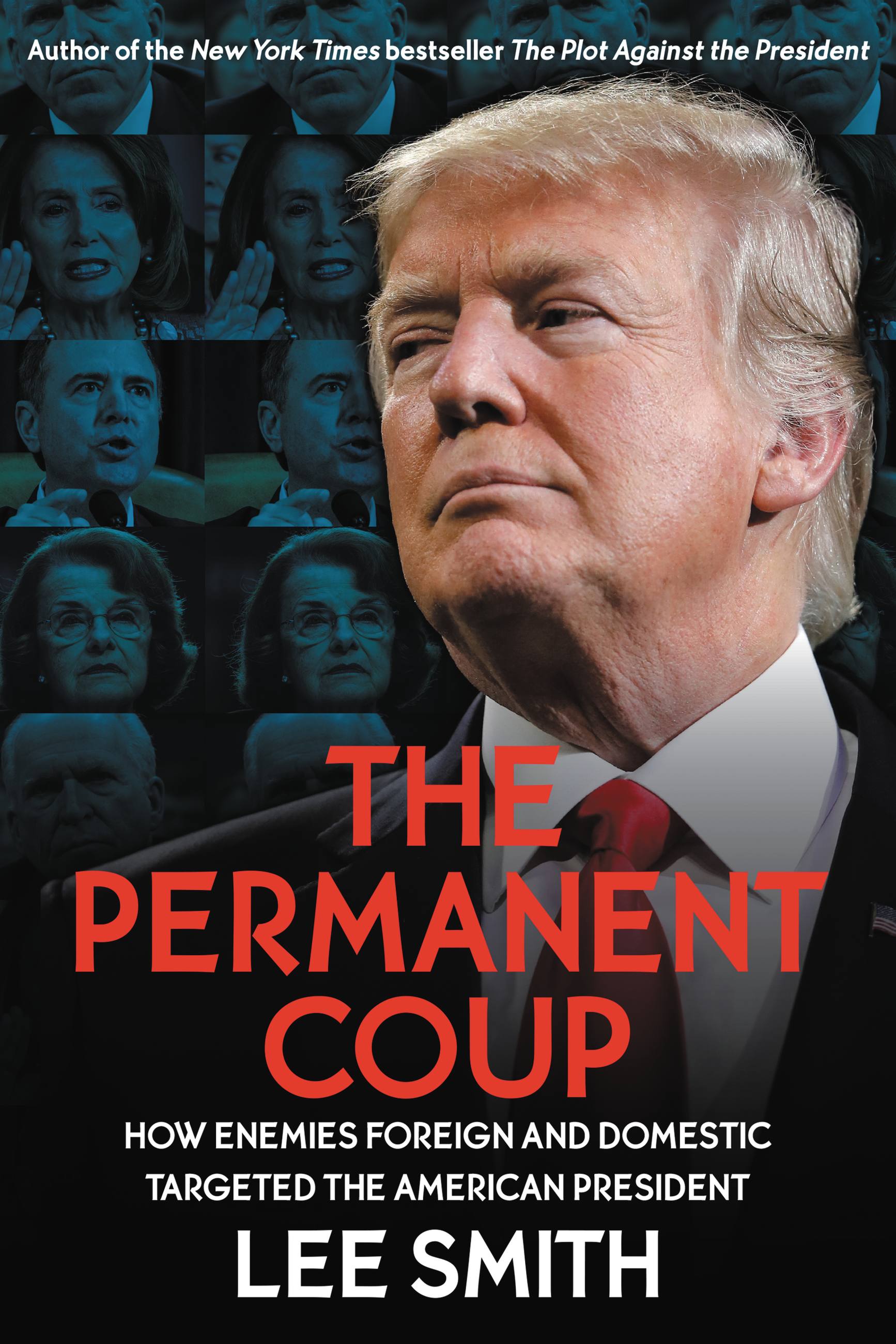
The Permanent Coup From the phony Russia collusion narrative to the coordinated riots laying waste to US cities, it's the same ongoing operation orchestrated by the left and targeting not just President Trump but hundreds of millions of Americans who revere their country and what it stands for. For the first time, crusading investigative journalist Lee Smith reveals who was responsible and the never before known involvement of Barack Obama, Joe Biden, and senior military officials who engineered a coup against a sitting president. Beginning in late 2015, political operatives, intelligence officials, and the press pushed a conspiracy theory about Trump-he was a Russian asset and spied on his campaign and his presidency in order to undo an election. Because the ultimate goal of the anti-Trump operation is not simply to topple the president but rather to change the character and constitution of the country, the Deep State's machinations didn't stop even after Trump was cleared of charges of "colluding" with Moscow. Their efforts became even more fierce, more desperate, and more divisive, threatening to scar America permanently. In their zeal to bring down President Trump, Deep State conspirators had unwittingly revealed the origins of the anti-Trump operation and exposed corruption at the very highest levels of the Democratic party-including former Vice President Biden and his boss, Barack Obama. Lee Smith brings to this story the same incisive reporting and commentary that distinguished his runaway bestseller, The Plot Against the President. His investigation, identifying crimes and abuses committed by senior US officials, was later confirmed by a major Department of Justice report. For The Permanent Coup, Smith again enjoys unrivaled and exclusive access to the main players defending America and uncovering Deep State crimes-including Congressman Devin Nunes and the president's personal lawyer, Rudy Giuliani. POLITICAL SCIENCE,American Government,National

A Republic Under Assault In this explosive new book, New York Times bestselling author and president of Judicial Watch Tom Fitton explains how the Radical Left and the Deep State are trying to destroy the Trump presidency. Tom Fitton’s first two New York Times bestselling books, The Corruption Chronicles and Clean House, exposed the hypocrisy and corruption of Obama’s two terms. Now, in Fitton’s latest investigative probe, he identifies the four major forces posing a continued threat to American democracy. Deep State Efforts to Destroy the Trump Presidency: How the Democratic National Committee and the Clinton campaign paid for the fraudulent anti-Trump “Steele Dossier,†and how it was used by the Obama FBI and DOJ to dupe the FISA Court to allow it to spy on the Trump presidential campaign AND President Trump. These and more dirty secrets of Obamagate and the impeachment coup attempt are exposed. Hillary Clinton Email Scandal: How the Clinton team and senior officials at the Obama State Department conspired to cover up Hillary Clinton’s secret email system—and shocking revelations that tie the Obama White House to the cover-up! Voter Fraud: How Soros-funded groups attack states that seek to protect clean elections by challenging voter ID laws, and how the Left is cynically peddling COVID-19 crisis electoral “reforms,†such as mail-in voting, which could increase voter fraud and election chaos. And shocking numbers about dirty voting rolls across the nation! Illegal Immigration: How deadly illegal “sanctuary†policies are exploding across America, and how our nation’s sovereignty has been under assault by radical open-border advocates. Subversive Deep State collaborators with ties to the Clinton and Obama machines not only launched countless—often illegal—operations to stop and then remove Trump, but even more alarmingly, are working to transform the United States into something truly unrecognizable to all who believe in liberty and the rule of law. Today one of their main targets is President Donald J. Trump. Tomorrow it could be you and anyone who believes in the US Constitution, believes the United States must have clearly defined and protected borders, believes in the need for a strong military, believes in the value of hard work and faith, and believes in the rule of law and American exceptionalism. POLITICAL SCIENCE,American Government,National
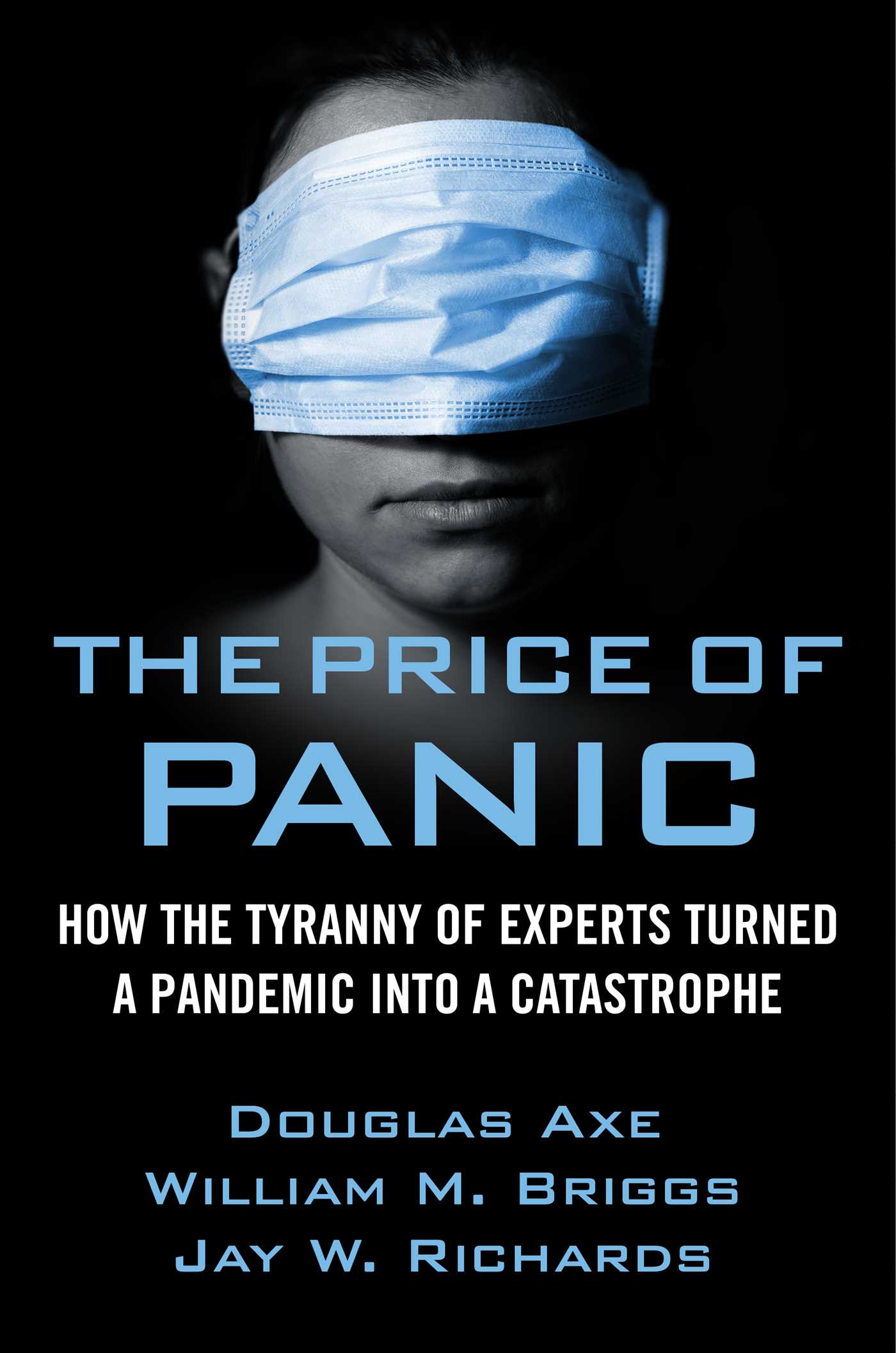
The Price of Panic For the first time in history, the world shut itself down—by choice—all for fear of a virus, COVID-19, that wasn’t well understood. The government, with the support of most Americans, ordered the closure of tens of thousands of small businesses—many never to return. Almost every school and college in the country sent its students home to finish the school year in front of a computer. Churches cancelled worship services. “Social distancing†went from a non-word to a moral obligation overnight. Moral preening on social media achieved ever new heights. The world will reopen and life will go on, but what kind of world will it be when it does? It can’t be what it was, because of what’s just happened. Professors Jay Richards, William Briggs, and Douglas Axe take a deep dive into the crucial questions on the minds of millions of Americans during one of the most jarring and unprecedented global events in a generation. What will be the total cost in dollars, lives, and livelihoods of this response from governments, on advice from Science? What role have national and global health organizations such as WHO played in this? To whom are they accountable? What evidence do they rely on in sounding the alarm? How did science bureaucrats, relying on murky data and speculative computer models, gain the power to shut down the global economy? How did politicians, who know nothing of the science, decide whom to trust? We need to know what and how it happened, to keep it from ever happening again. POLITICAL SCIENCE,American Government,National
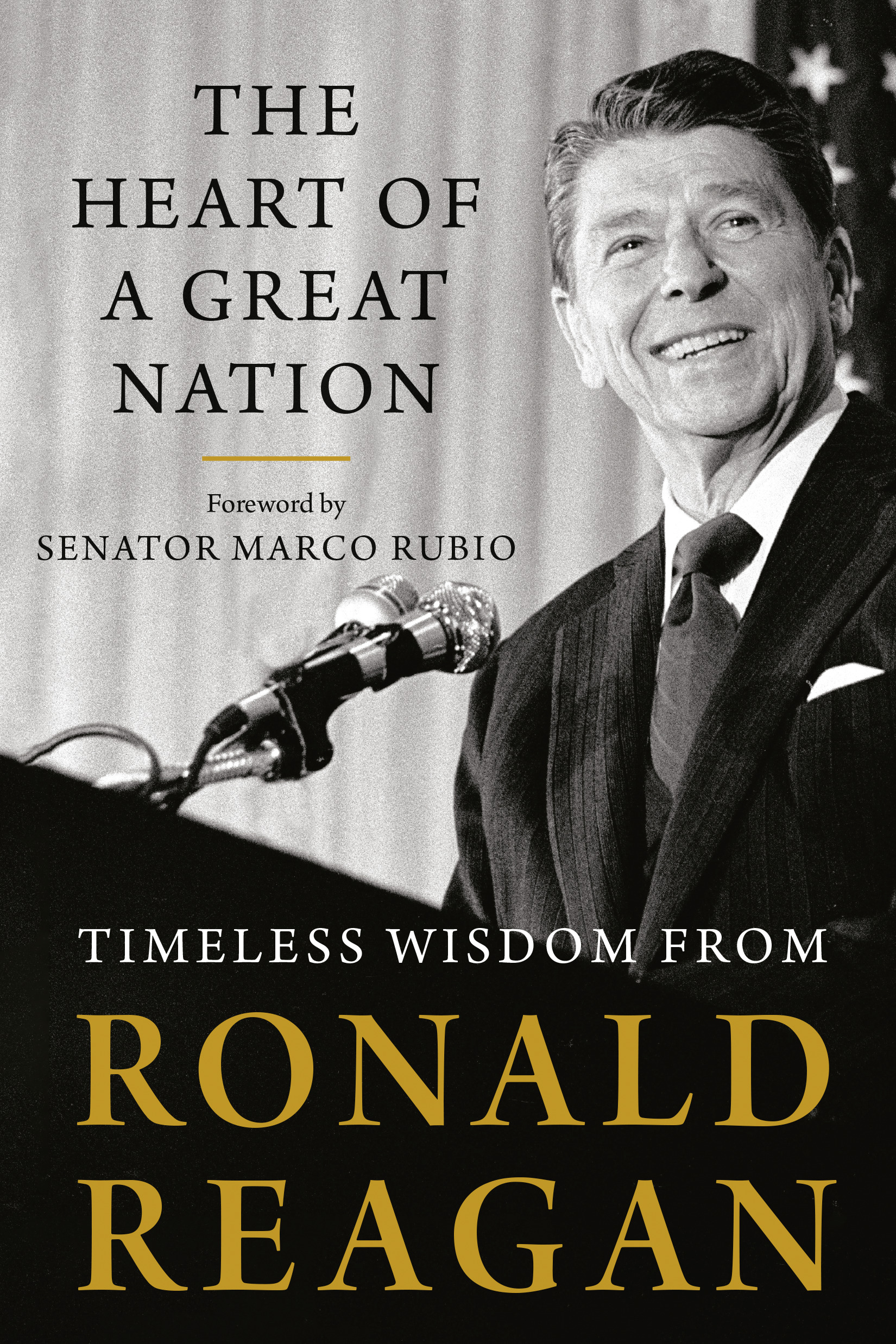
The Heart of a Great Nation With a foreword from Senator Marco Rubio, a stirring collection of Ronald Reagan's most inspiring speeches, offering his timeless wisdom and guidance for our day. In his 1989 farewell address, Ronald Reagan said, "I wasn't a great communicator, but I communicated great things, and they didn't spring full bloom from my brow, they came from the heart of a great nation--from our experience, our wisdom, and our belief in principles that have guided us for two centuries." The Heart of a Great Nation brings together Reagan's most powerful speeches, as relevant to our chaotic world as they were when he first gave them. In a period of our country's history consumed by economic stagnation, national instability, and the looming threat of communism, Reagan spoke directly to the hearts of everyday Americans. His wisdom on matters of family, freedom, and nationhood helped guide the country back to its founding principles and ushered in an era of prosperity and national pride. Today, as we find our country treading similar ground, Reagan's wisdom speaks to us once again, offering guidance to everyone looking to navigate the present and remember the legacy of this great nation--which can one day be reclaimed. POLITICAL SCIENCE,American Government,National
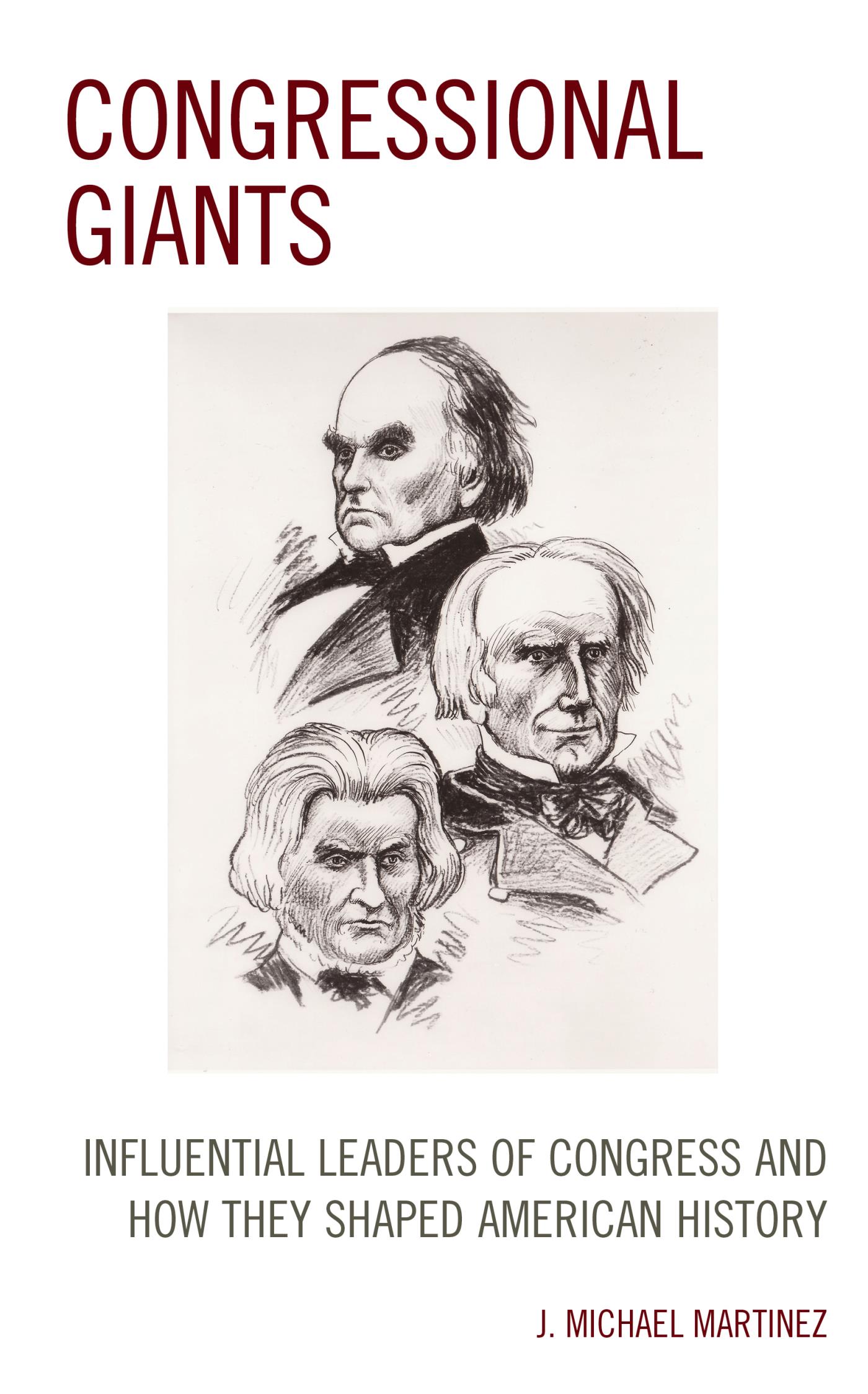
Congressional Giants Congressional Giants examines the lives and achievements of 14 influential leaders of Congress from the nineteenth century to the present day. These "giants" shaped American history in myriad ways that continue to reverberate well into the twenty-first century. POLITICAL SCIENCE,American Government,National
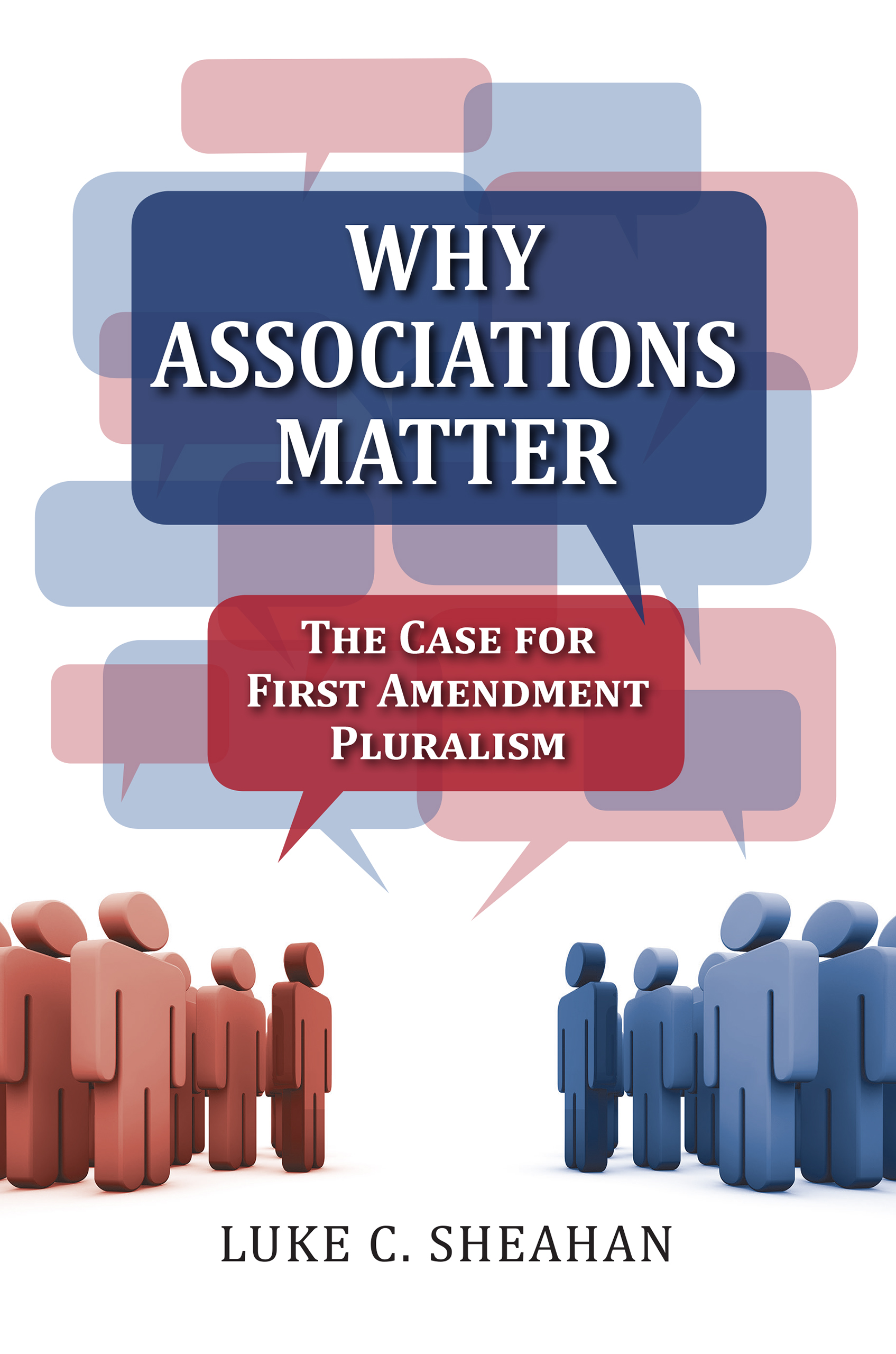
Why Associations Matter First Amendment rights are hailed as the hallmark of the US constitutional system, protecting religious liberty, freedom of speech, freedom of the press, and freedom of association. But among these rights, freedom of association holds a tenuous position, as demonstrated in the 2010 Supreme Court ruling in Christian Legal Society v. Martinez, which upheld a public university’s policy requiring groups seeking official recognition to accept all students regardless of their status or beliefs. This demotion of freedom of association has broad ramifications for the constitutional status of voluntary associations in civil society, Luke C. Sheahan suggests. His book offers a cogent explanation of how this came about, why it matters, and what might be done about it. Sheahan’s argument centers upon what he calls the “First Amendment Dichotomy†in the Court’s theoretical framework: an understanding of the state and the individual as the two analytically exclusive units of constitutional analysis. Why Associations Matter traces this dichotomy through Supreme Court jurisprudence culminating in Martinez, revealing a pattern of free association treated only as an individual right of expressive association derived from the Speech Clause alone. Sheahan then draws on the political sociology of Robert Nisbet to make a case for recognizing the social importance of associations and institutions that cannot be reduced to their individual members or subsumed into the state for purposes of constitutional analysis. Translating the sociological qualities of associations into jurisprudential categories, Why Associations Matter provides practical advice for protecting freedom of association through the judiciary and the legislature—and guaranteeing this fundamental right its proper place in American society. POLITICAL SCIENCE,American Government,National
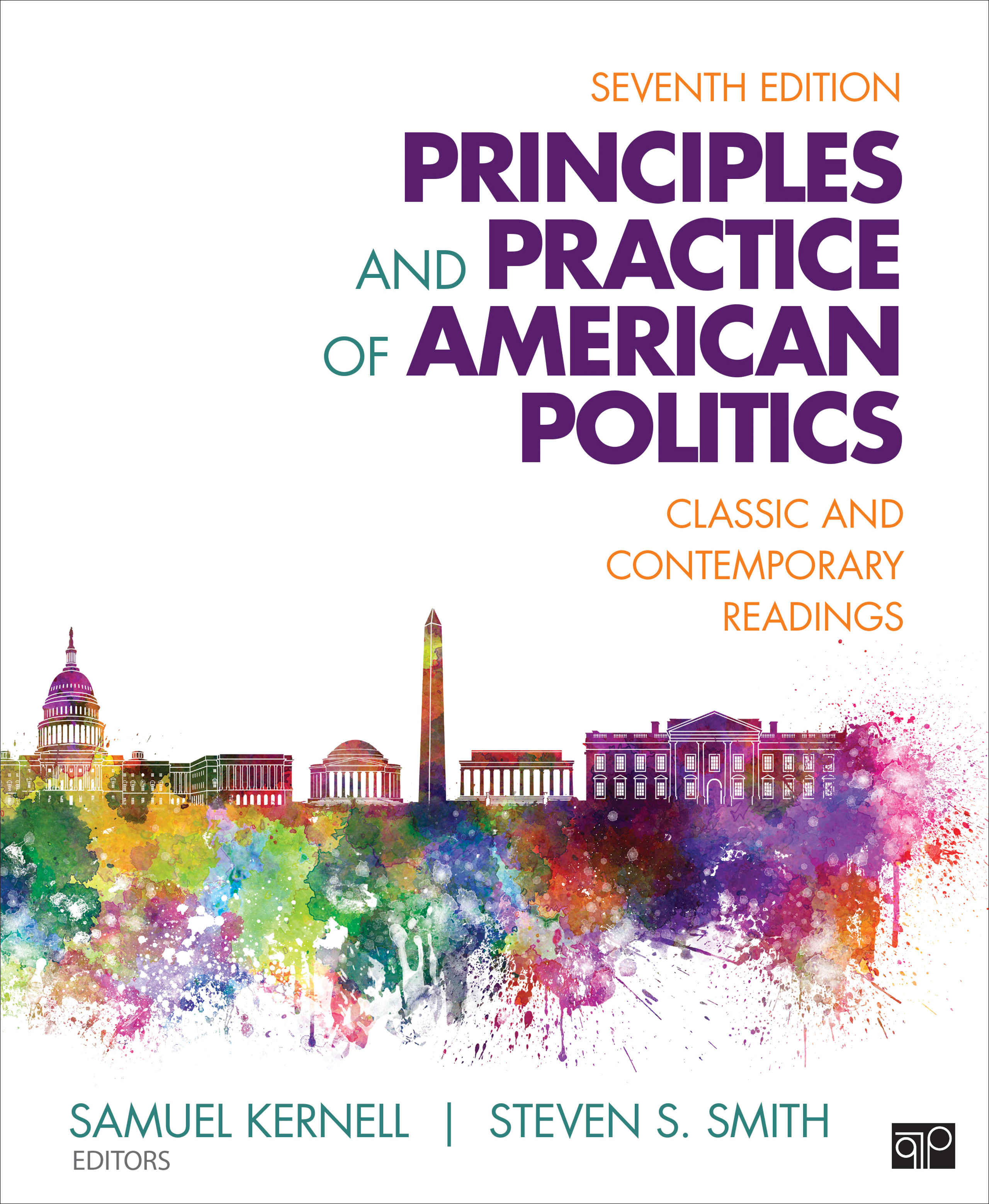
Principles and Practice of American Politics Combining timeless readings with cutting-edge articles and essays, Principles and Practice of American Politics , Seventh Edition, enriches your understanding of the American political system by examining the strategic behavior of key players in U.S. politics. This collection of classic and contemporary readings brings concepts to life by providing you with real examples of how political actors are influenced by the strategies of others and are governed by the Constitution, the law, and institutional rules. Carefully edited by award-winning authors Samuel Kernell and Steven S. Smith, each reading is put into context to help you understand how political actions fall within a major national political forum. New to the Seventh Edition Nine new and updated essays encourage you to reflect on the continuing debates over the polarization of the American electorate and Congress, the role of social media and “fake news†in influencing public views of politicians and issues, the fragile Trump coalition, the efficacy of polling in tracking public opinion, and other issues more relevant than ever in the wake of the 2016 elections. Additional essays challenge you to think more carefully about alternative institutions and political arrangements . The new essays present institutions of majority rule, the nature of racial discrimination, and the proper role of the court as less settled issues that provide students an opportunity to think through (and discuss) their views on the future direction of American civic life. Each selection is artfully framed by Kernell and Smith’s contextual headnotes to make them appropriate for classroom use. Original readings written specifically for the volume give the book a coherent treatment of the performance of U.S. political institutions. POLITICAL SCIENCE,American Government,National
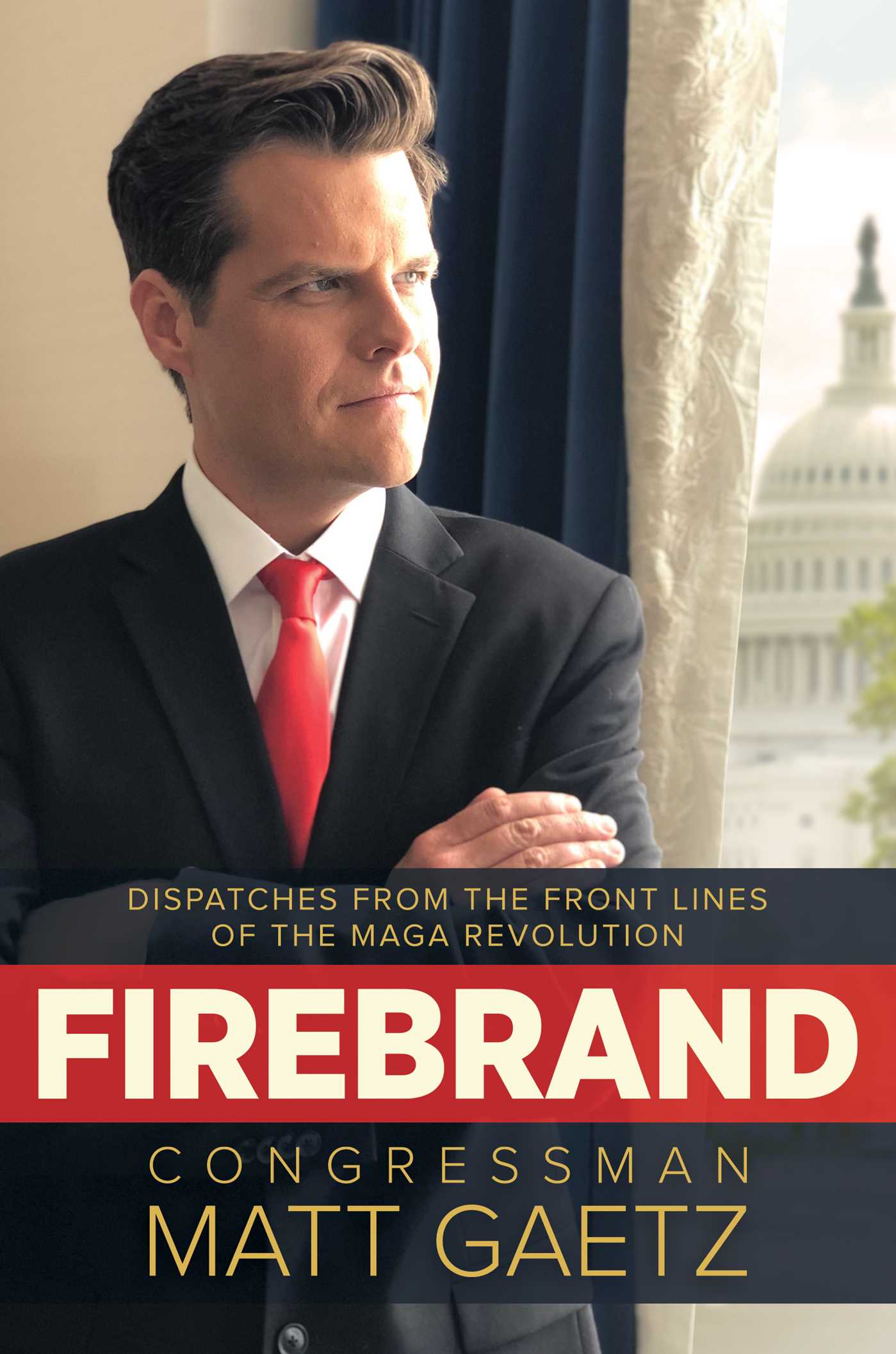
Firebrand In a scathingly funny account of his time in the Washington swamp, Florida firebrand Matt Gaetz, one of President Trump’s key supporters in Congress, gleefully skewers the enemies of the MAGA revolution and lays out his own vision for the future of the populist movement. “This book is your invitation to the front lines of our fight. Join me with ideas, energy, images, and stories. This is not my chronological diary. You can watch me on television for that. This is how we prevail with joy—and exactly how an exciting president is leading the way against all odds.†—Congressman Matt Gaetz POLITICAL SCIENCE,American Government,National
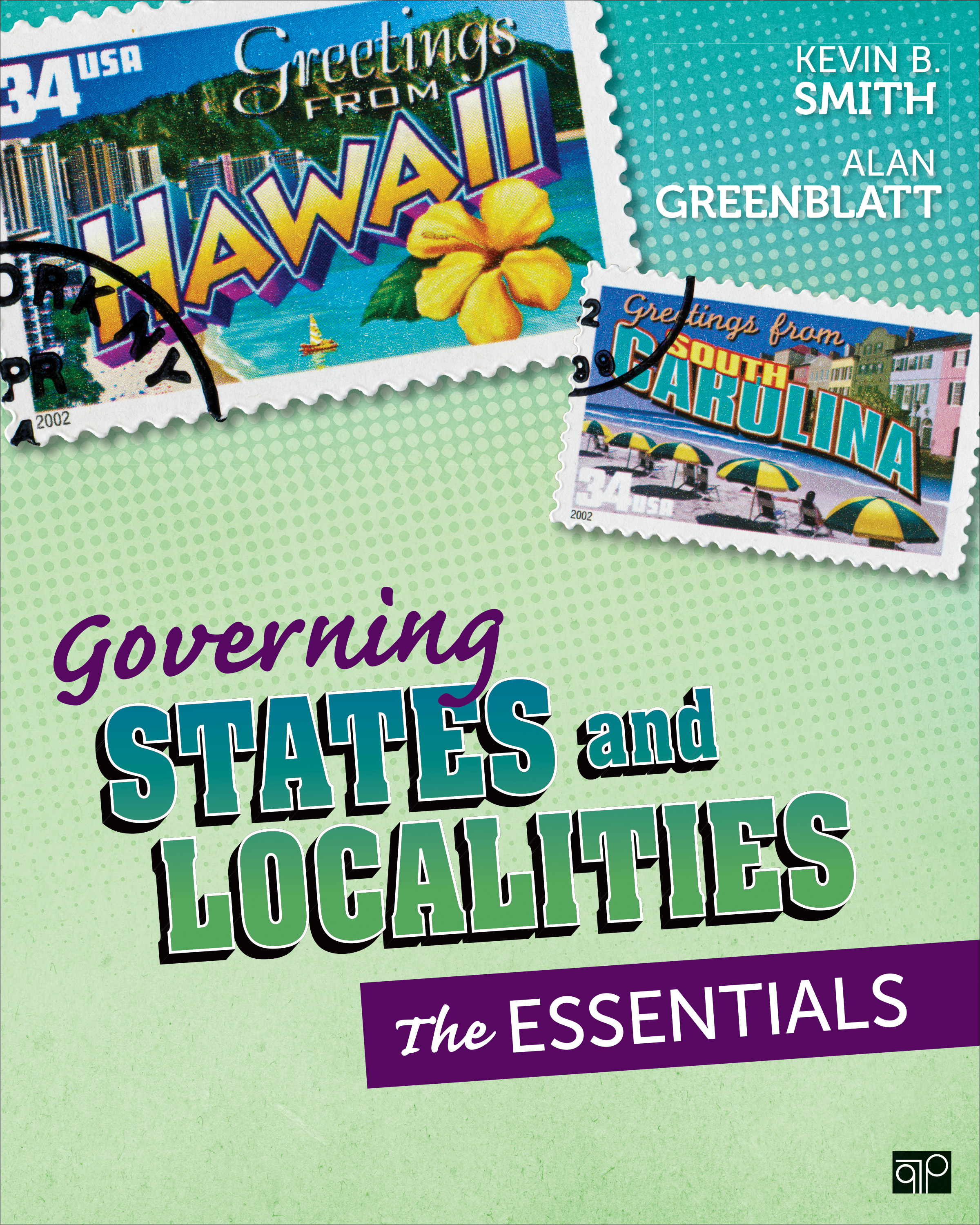
Governing States and Localities In this Essentials Edition of Governing States and Localities , authors Kevin Smith and Alan Greenblatt retain the hallmarks of their bestselling introductory text by blending the latest scholarship with engaging journalistic writing, crisp storytelling, and class-tested pedagogy. Based on market feedback, the authors distilled core topics and cut out policy coverage some instructors do not have time to cover, but kept the ever-important finance chapter and a beautiful full-color interior design. This value-priced, ten-chapter text utilizes the comparative approach to ensure that students walk away from the course understanding how and why states and localities are both similar and different in institutional structure, culture, history, geography, economy, and demographics POLITICAL SCIENCE,American Government,State
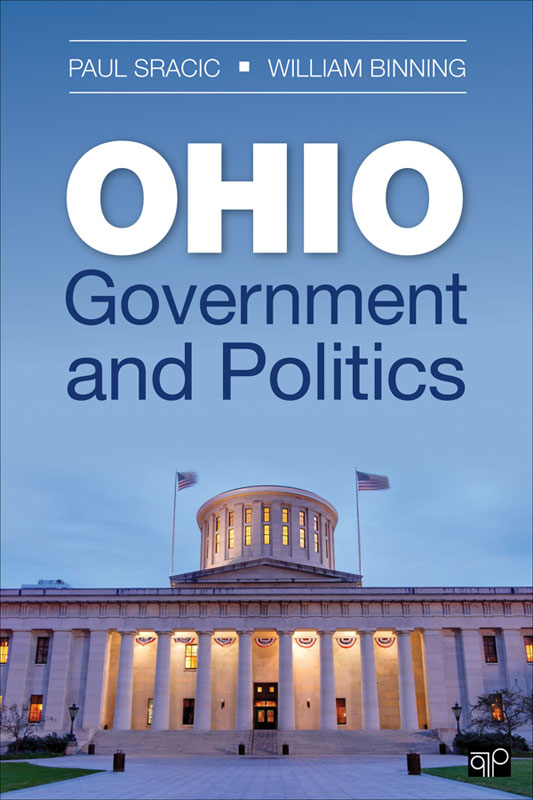
Ohio Government and Politics Ohio Government and Politics provides a thorough, highly readable overview of the history, processes, and institutions of the state’s government and politics. In a country increasingly divided into blue and red states, Ohio is “purple†– one of the few states that is not dominated by a single political party. Covering the crucial strategies of both the republicans and democrats as they vie for power in Ohio, authors Paul Sracic and William Binning demonstrate the “nationalizing†of Ohio politics. However, contemporary issues specific to Ohio politics are not neglected; coverage of important issues such charter reform in Cuyahoga County and the controversies over the regulation of "fracking" is included. POLITICAL SCIENCE,American Government,State
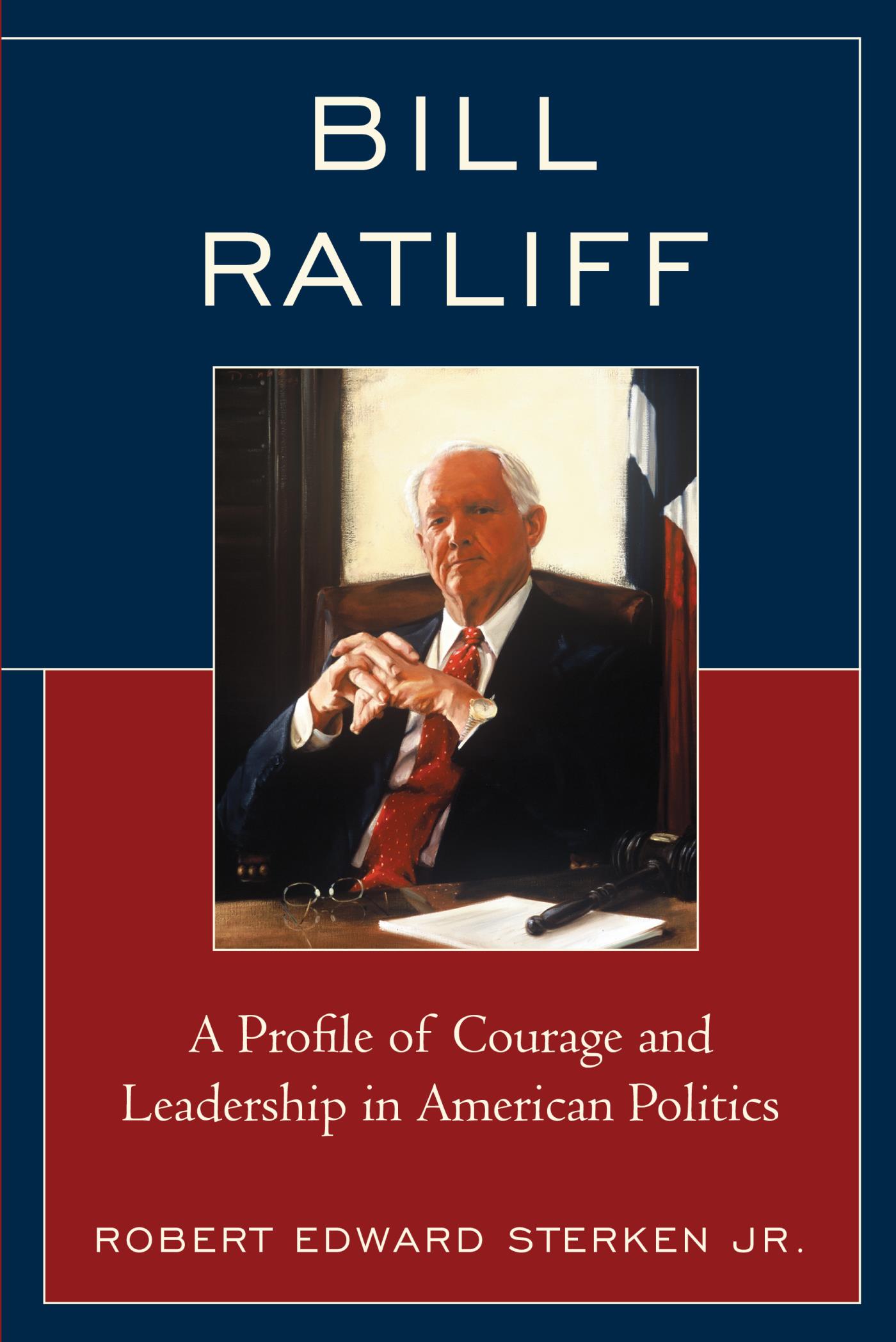
Bill Ratliff This book is a celebration of American values as shown by former Texas State Senator and politician Bill Ratliff, a leader in Texas politics who wrote school finance law, major Ethics reform law, and Texas tort reform law. This story will inspire students to service, politicians to greatness, and American citizens to rethink narrow partisanship. POLITICAL SCIENCE,American Government,State
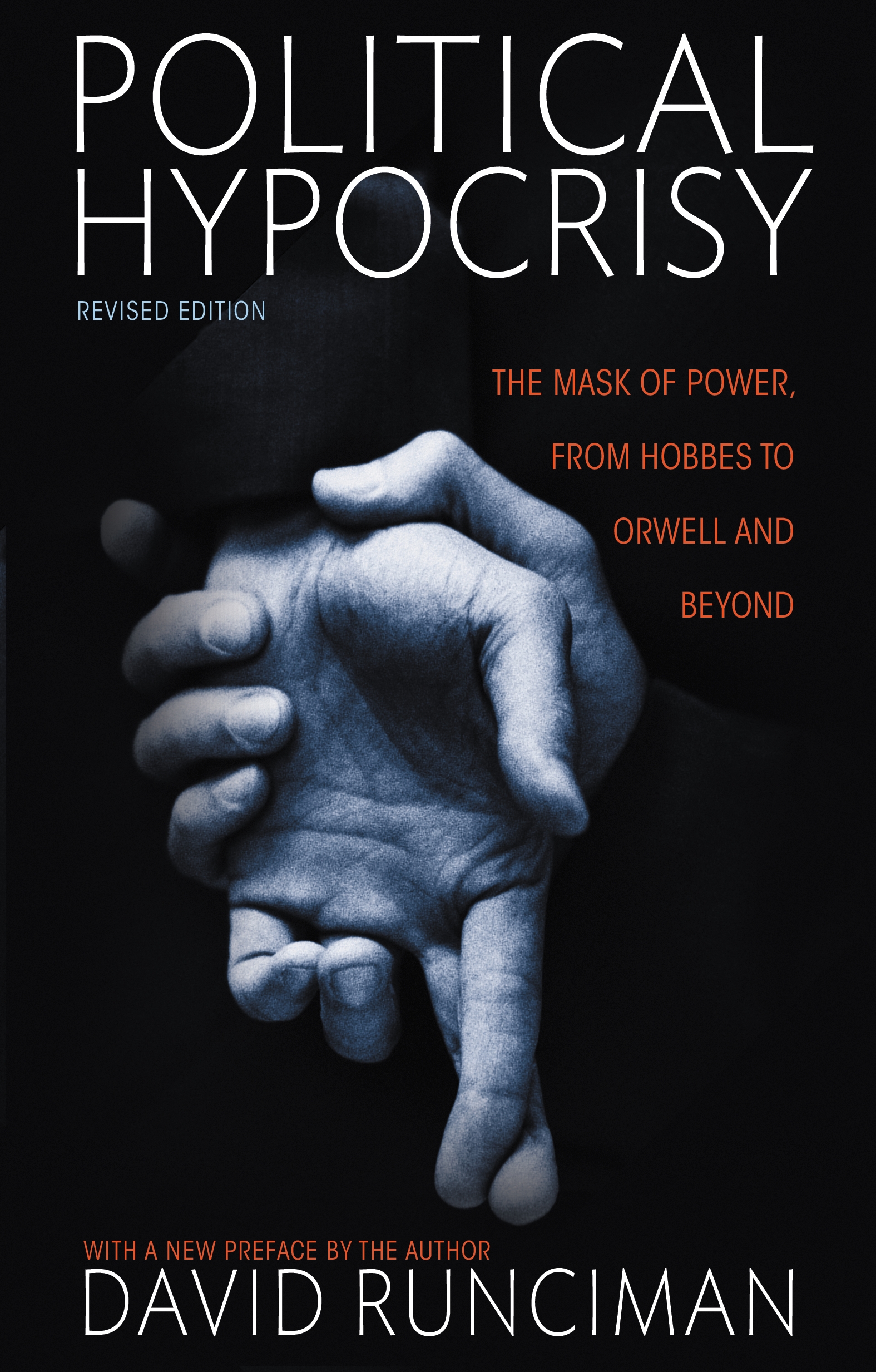
Political Hypocrisy What kind of hypocrite should voters choose as their next leader? The question seems utterly cynical. But, as David Runciman suggests, it is actually much more cynical to pretend that politics can ever be completely sincere. Political Hypocrisy is a timely, and timeless, book on the problems of sincerity and truth in politics, and how we can deal with them without slipping into hypocrisy ourselves. Runciman draws on the work of some of the great truth-tellers in modern political thought--Hobbes, Mandeville, Jefferson, Bentham, Sidgwick, and Orwell--and applies his ideas to different kinds of hypocritical politicians from Oliver Cromwell to Hillary Clinton. He argues that we should accept hypocrisy as a fact of politics--the most dangerous form of political hypocrisy is to claim to have a politics without hypocrisy. Featuring a new foreword that takes the story up to Donald Trump, this book examines why, instead of vainly searching for authentic politicians, we should try to distinguish between harmless and harmful hypocrisies and worry only about the most damaging varieties. POLITICAL SCIENCE,American Government,State
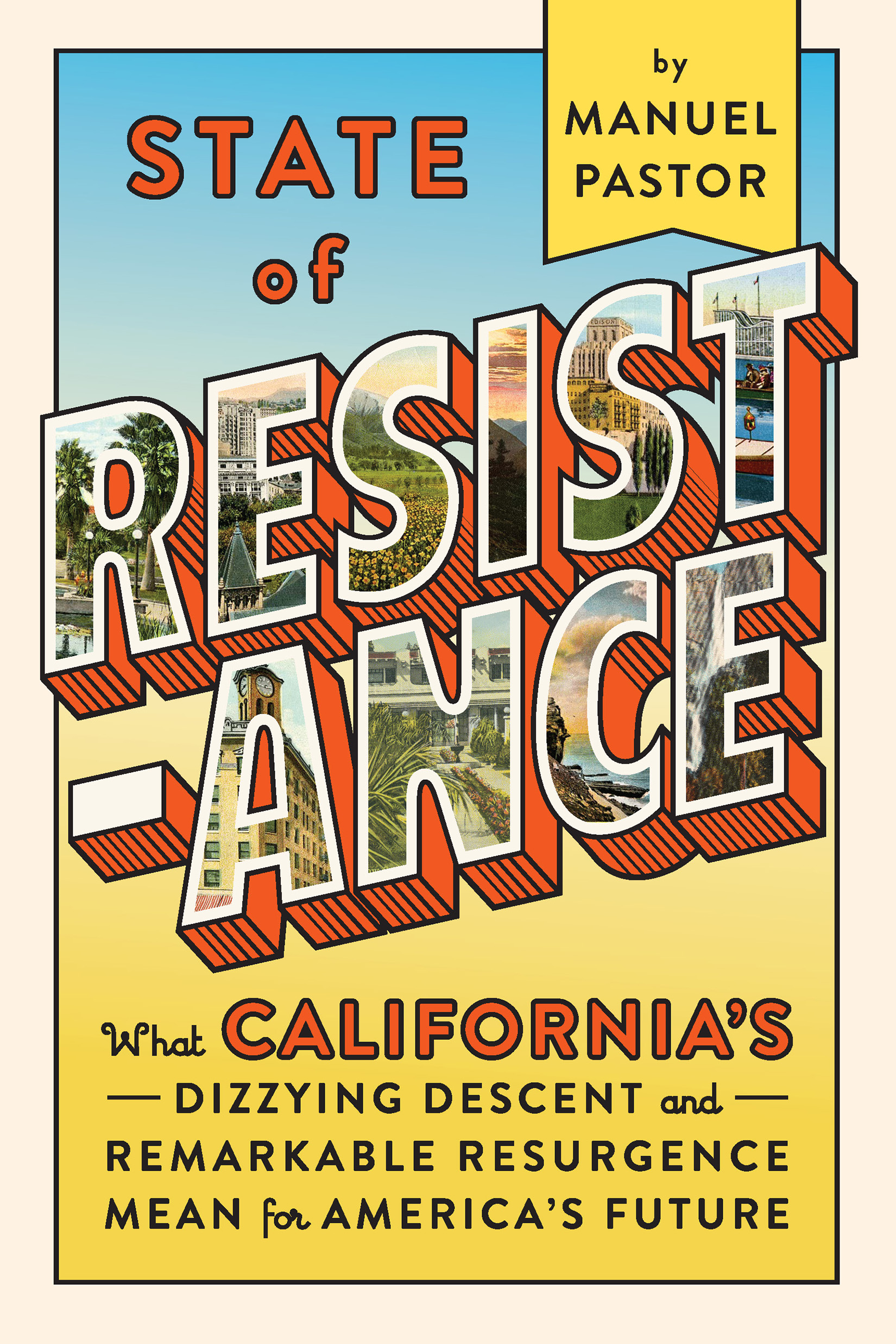
State of Resistance Concise, clear and convincing. . . a vision for the country as a whole.†James Fallows, The New York Times Book Review A leading sociologist’s brilliant and revelatory argument that the future of politics, work, immigration, and more may be found in California Once upon a time, any mention of California triggered unpleasant reminders of Ronald Reagan and right-wing tax revolts, ballot propositions targeting undocumented immigrants, and racist policing that sparked two of the nation’s most devastating riots. In fact, California confronted many of the challenges the rest of the country faces now—decades before the rest of us. Today, California is leading the way on addressing climate change, low-wage work, immigrant integration, overincarceration, and more. As white residents became a minority and job loss drove economic uncertainty, California had its own Trump moment twenty-five years ago, but has become increasingly blue over each of the last seven presidential elections. How did the Golden State manage to emerge from its unsavory past to become a bellwether for the rest of the country? Thirty years after Mike Davis’s hellish depiction of California in City of Quartz, the award-winning sociologist Manuel Pastor guides us through a new and improved California, complete with lessons that the nation should heed. Inspiring and expertly researched, State of Resistance makes the case for honestly engaging racial anxiety in order to address our true economic and generational challenges, a renewed commitment to public investments, the cultivation of social movements and community organizing, and more. POLITICAL SCIENCE,American Government,State
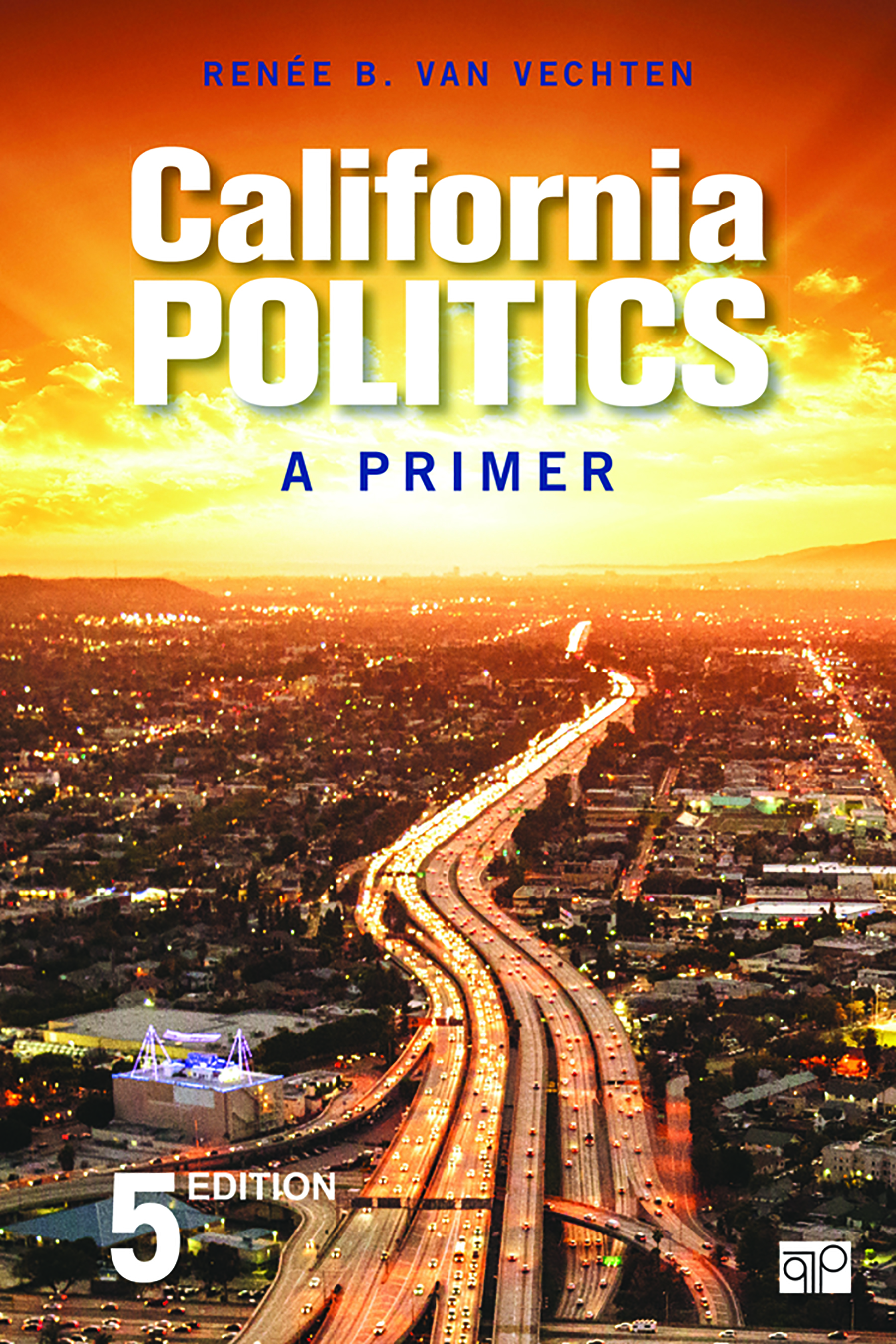
California Politics The thoroughly revised Fifth Edition of California Politics: A Primer concisely explains how California’s history, political culture, rules, and institutions come together to shape politics today and how they will determine the state of affairs tomorrow. Author Renee B. Van Vechten begins with a brief political history of California, then walks through direct democracy, the legislature, executive branch, and court system. She covers local government and concludes with a discussion of the state’s budget process, campaigns and elections, political engagement, and policy issues. From the structure of the state's government to its local representatives, policies, and voter participation, California Politics: A Primer delivers the concepts and details students need. New to the Fifth Edition An emphasis on California’s place in the federal system provides you with context around the state leadership's resistance to Trump administration policies on things like California’s sanctuary state status, immigration, the environment, and more. Increased coverage of policy topics throughout the book helps you see how recent policy has impacted issues such as greenhouse gas emissions regulations, attempted “fixes†for water- and drought-related issues, new transportation projects, and prison reform. Extended discussions of elections-related innovations introduce you to recent elections-related topics such as the Top-Two Primary, efforts to increase voter registration, all vote-by-mail elections, and redistricting. New coverage of the “Five Californias†gives you a better understanding of California’s political geography and how distinct segments of the population are primed for political engagement or disaffection. New lists of key terms with clear definitions at the end of each chapter enable you to review the content more effectively. New and updated maps and graphics depict important topics such as California’s newly proposed high-speed rail project. POLITICAL SCIENCE,American Government,State
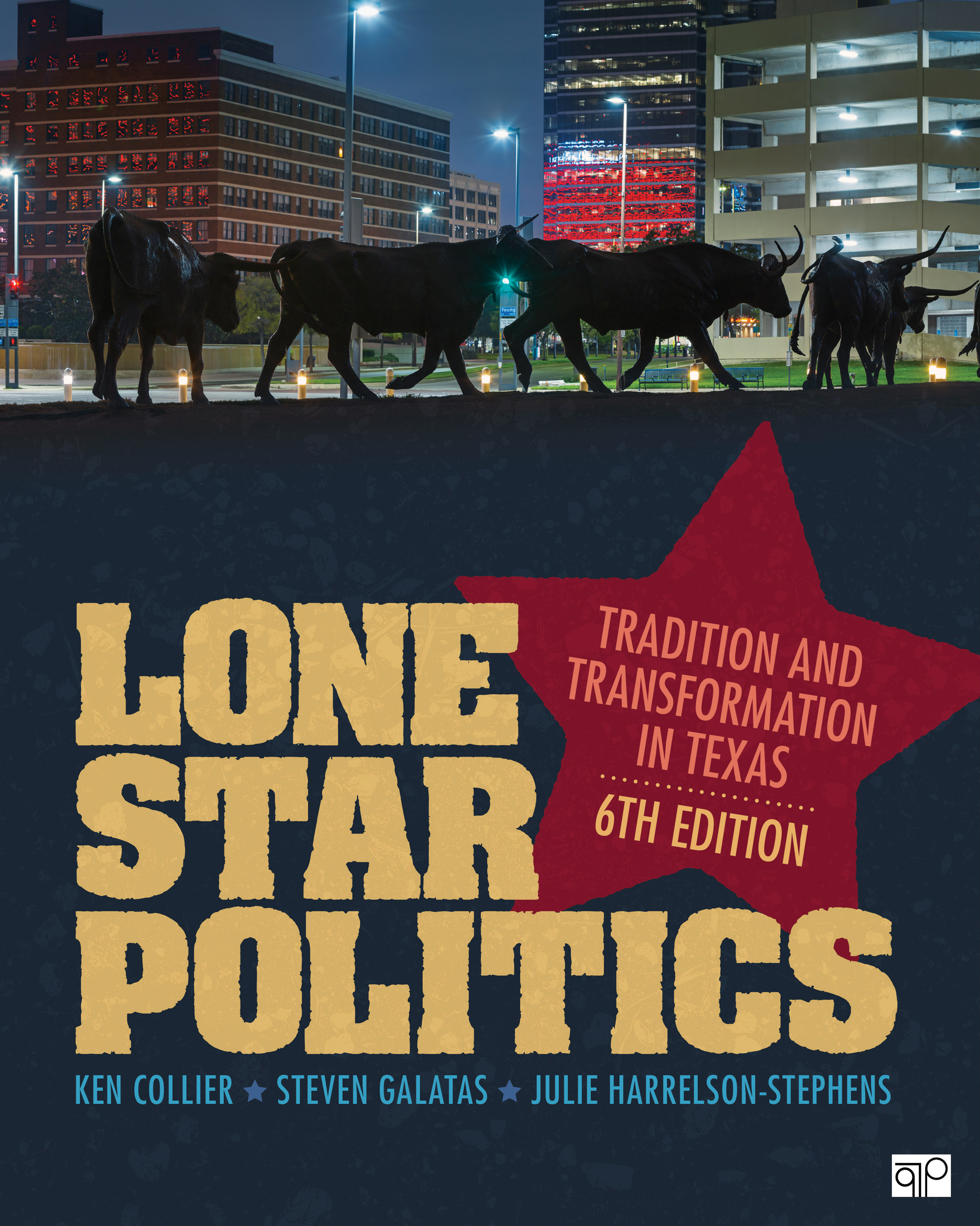
Lone Star Politics In Texas, myth often clashes with the reality of everyday government. Explore the state's rich political tradition with Lone Star Politics as this local author team explains who gets what and how. Utilizing the comparative method, Ken Collier, Steven Galatas, and Julie Harrelson-Stephens set Texas in context with other states' constitutions, policymaking, electoral practices, and institutions as they delve into the evolution of its politics. Critical thinking questions and unvarnished "Winners and Losers" discussions guide students toward understanding Texas government and assessing the state's political landscape. The Sixth Edition expands its coverage on civil rights in the state, as well as contemporary issues highlighting the push-pull relationship between the state and federal and local governments. POLITICAL SCIENCE,American Government,State
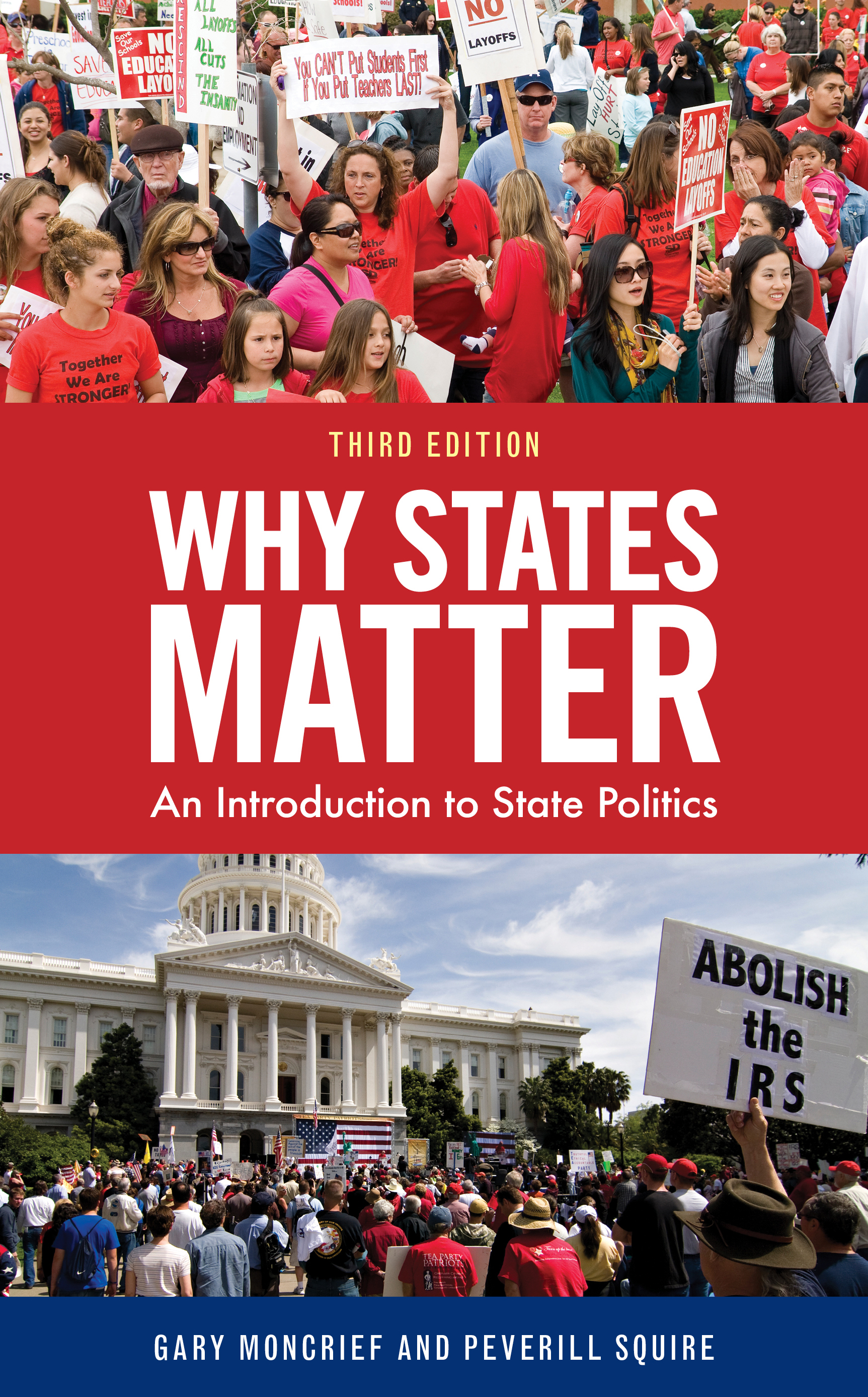
Why States Matter This book introduces students to the very tangible and constantly evolving implications, limitations, and foundations of America’s state political institutions, and accessibly explain the ways that the political powers of the states manifest themselves in the cultures, economies, and lives of everyday Americans, and always will. POLITICAL SCIENCE,American Government,State
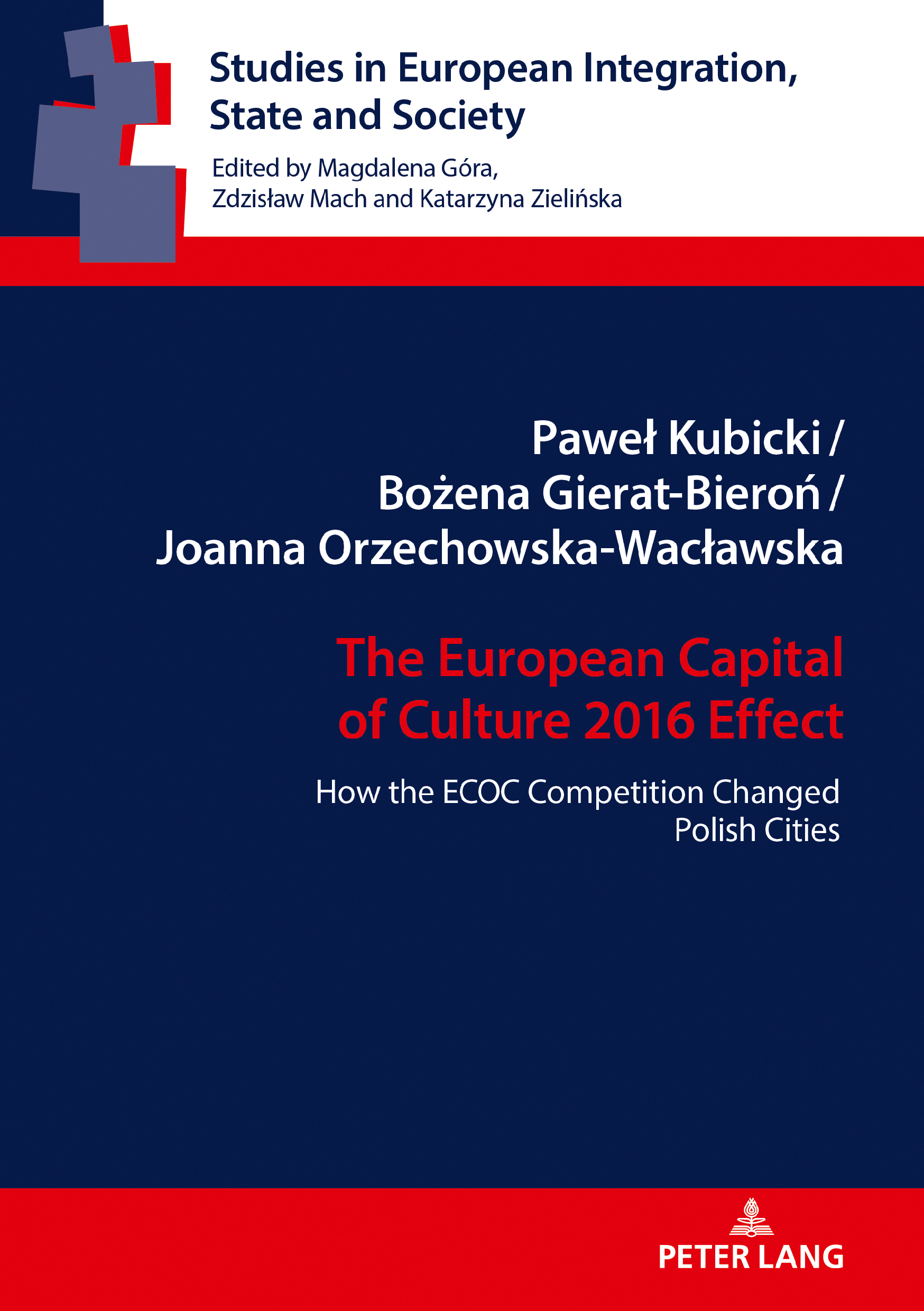
The European Capital of Culture 2016 Effect The book analyzes the set of consequences of Polish cities’ participation in the competition for the title of European Capital of Culture 2016, which was held between 2007 and 2011. POLITICAL SCIENCE,American Government,State

Future of The European Union Integration This book covers deep researches from different perspectives & disciplines on the future of the European Union by successful and expert researchers in their field. In this book, diverse and rigorous analyses of all areas were made in order to be one of the new reliable source about the European Union studies with various dimensions. POLITICAL SCIENCE,American Government,State
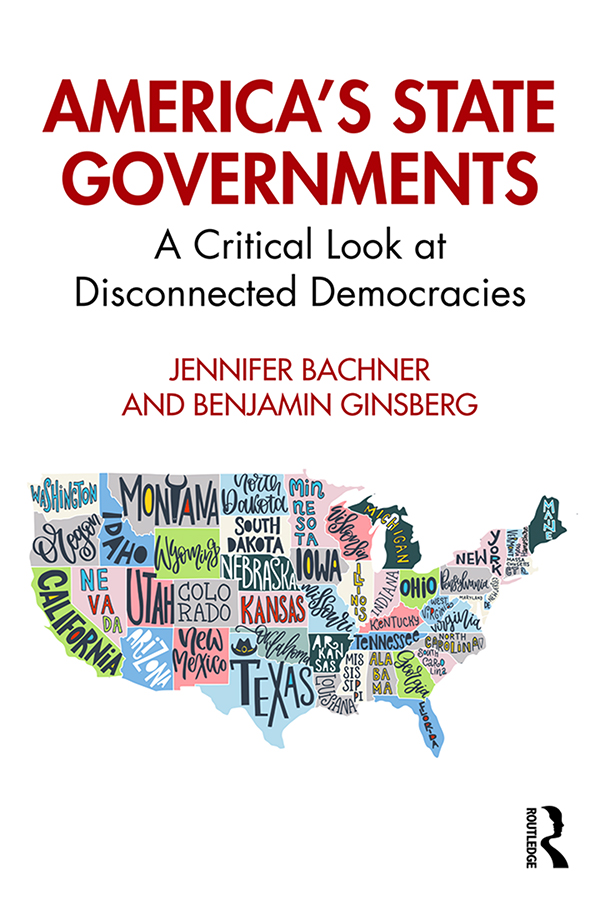
America's State Governments This timely and important new work takes a critical look at government in the American states and illustrates the disconnect between state government institutions and their constituents. The text illuminates three basic political problems of state governments: weak constitutional and institutional foundations; a lack of civic engagement; and long histories of unchecked public corruption. In addition, the book explains why some states did and others did not respond promptly to the COVID-19 pandemic and examines America's long-standing problem of police and prosecutorial misconduct–providing a context for understanding the demonstrations and protests that rocked American cities in the summer of 2020. For students and citizens of state politics, the book concludes with a proposal aimed at civic literacy and action POLITICAL SCIENCE,American Government,State
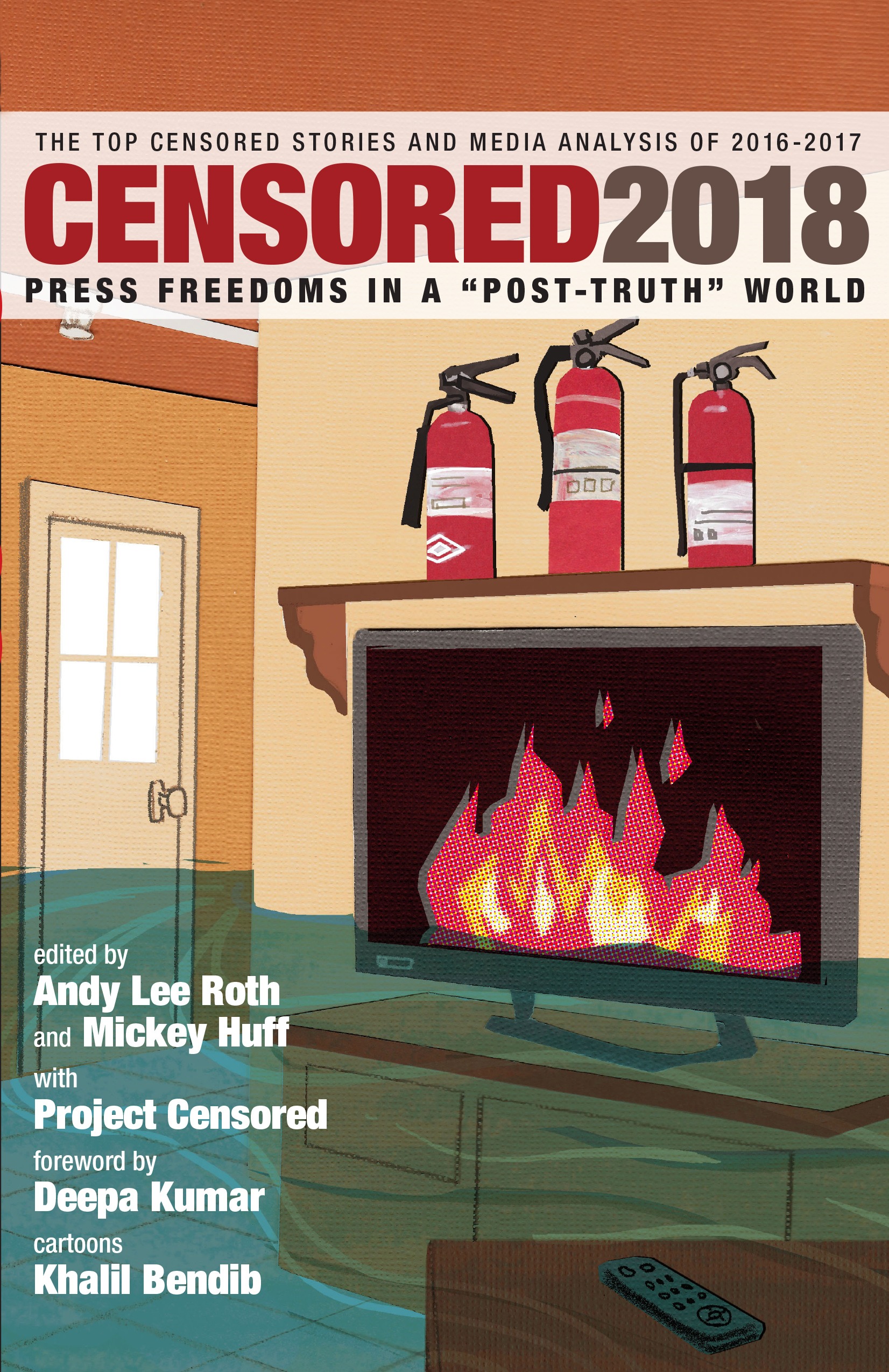
Censored 2018 "[Censored] should be affixed to the bulletin boards in every newsroom in America. And, perhaps, read aloud to a few publishers and television executives."--RALPH NADER The annual yearbook from Project Censored features the year's most underreported news stories, striving to unmask censorship, self-censorship, and propaganda in corporate-controlled media outlets. Featuring the top 25 most underreported stories, as voted by scholars, journalists, and activists across the country and around the world, as well as chapters exploring timely issues from the previous year with more in-depth analysis. POLITICAL SCIENCE,Censorship
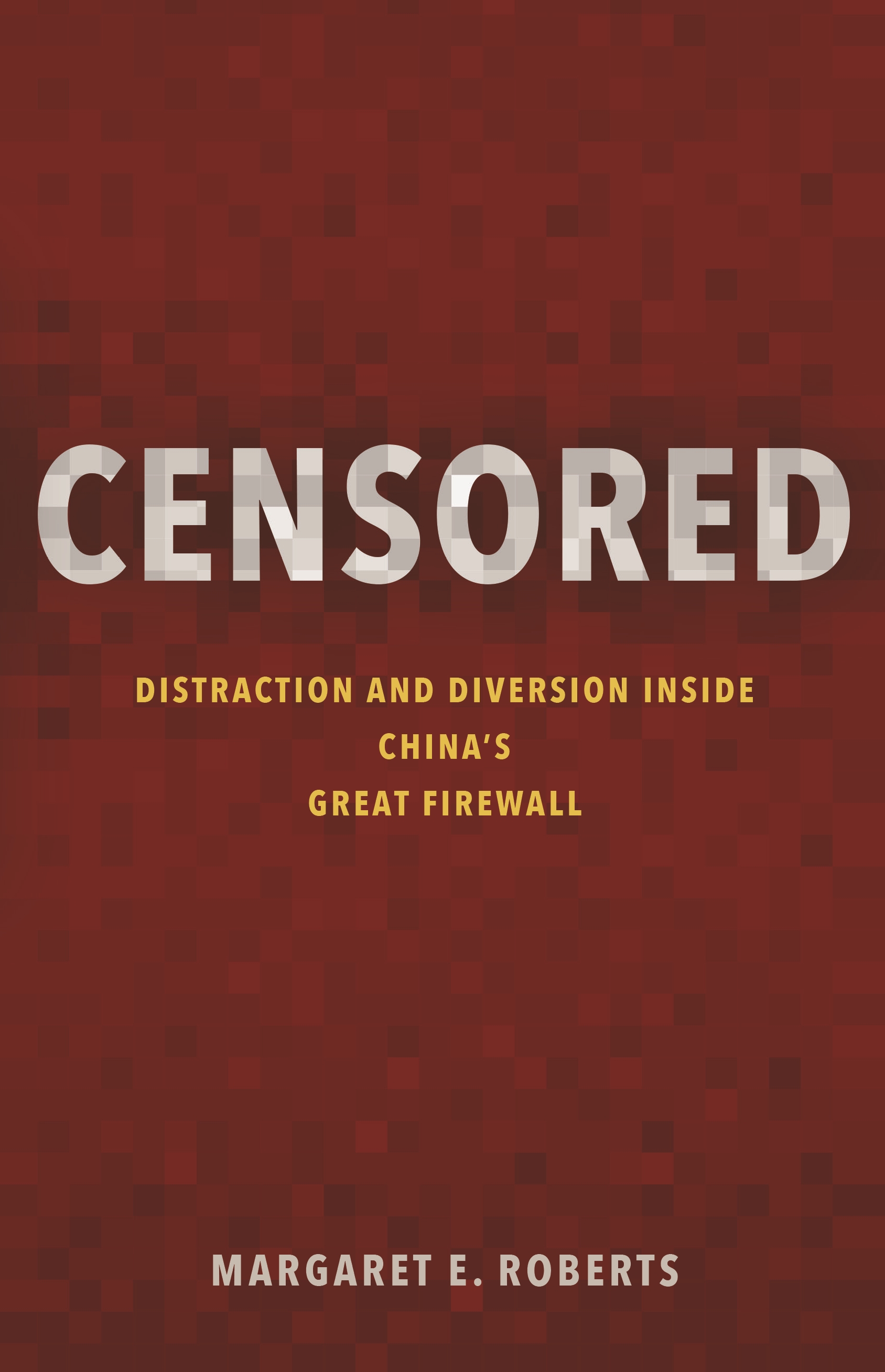
Censored A groundbreaking and surprising look at contemporary censorship in China As authoritarian governments around the world develop sophisticated technologies for controlling information, many observers have predicted that these controls would be ineffective because they are easily thwarted and evaded by savvy Internet users. In Censored, Margaret Roberts demonstrates that even censorship that is easy to circumvent can still be enormously effective. Taking advantage of digital data harvested from the Chinese Internet and leaks from China's Propaganda Department, this important book sheds light on how and when censorship influences the Chinese public. Roberts finds that much of censorship in China works not by making information impossible to access but by requiring those seeking information to spend extra time and money for access. By inconveniencing users, censorship diverts the attention of citizens and powerfully shapes the spread of information. When Internet users notice blatant censorship, they are willing to compensate for better access. But subtler censorship, such as burying search results or introducing distracting information on the web, is more effective because users are less aware of it. Roberts challenges the conventional wisdom that online censorship is undermined when it is incomplete and shows instead how censorship's porous nature is used strategically to divide the public. Drawing parallels between censorship in China and the way information is manipulated in the United States and other democracies, Roberts reveals how Internet users are susceptible to control even in the most open societies. Demonstrating how censorship travels across countries and technologies, Censored gives an unprecedented view of how governments encroach on the media consumption of citizens. POLITICAL SCIENCE,Censorship
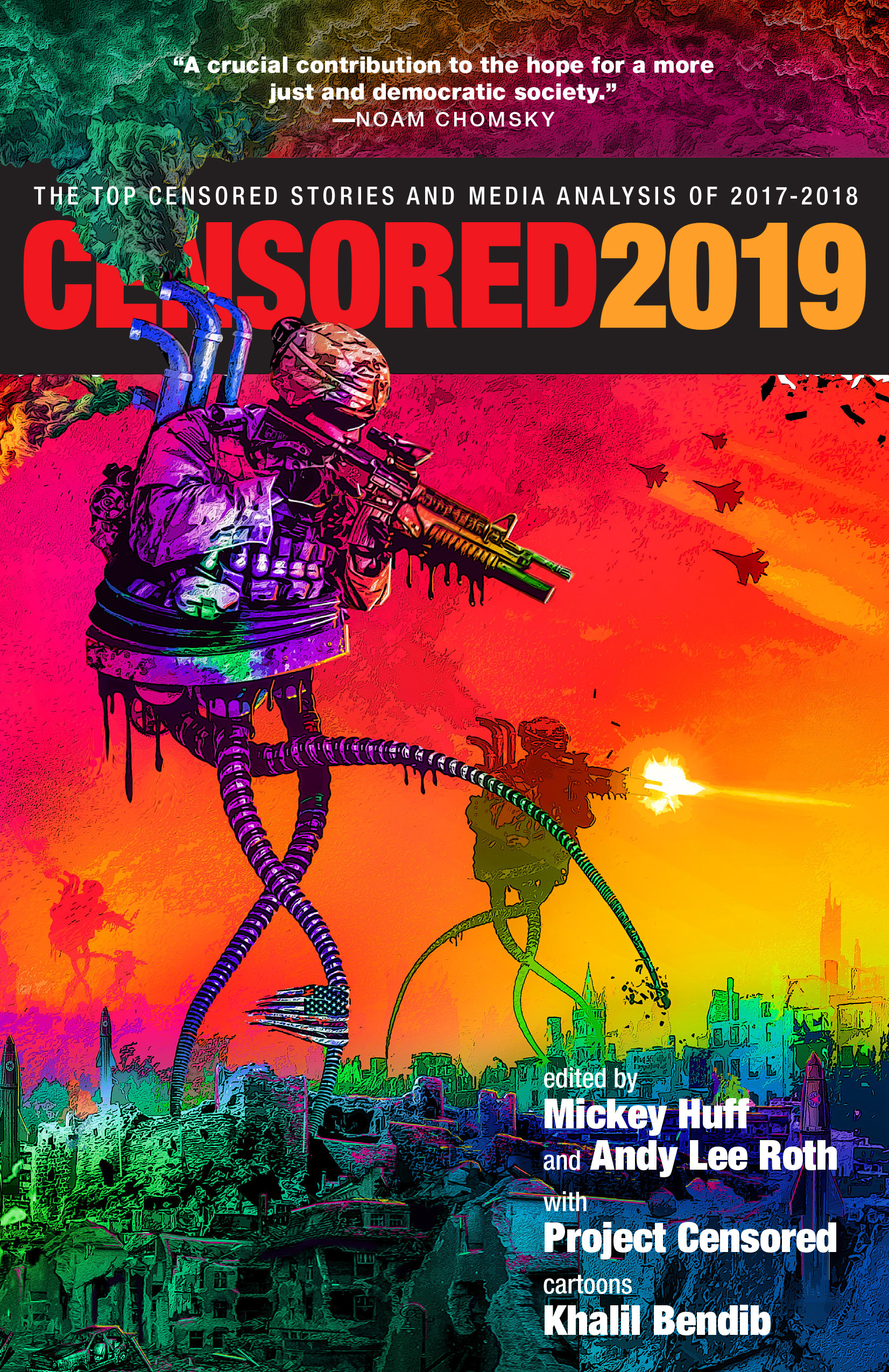
Censored 2019 “For more thanforty years, Project Censored has been our watchdog on the establishment media, casting its eye on how the information that we receive––and don’t receive––shapes our democracy. We need it more than ever today!”—Christopher Finan, Executive Director, National Coalition Against Censorship (NCAC) THESE ARE JUST A FEW OF THE STORIES PRESENTED IN CENSORED 2019:--“Open-Source” Intelligence Secrets Sold to Highest Bidders--ICE Intends to Destroy Records of Inhumane Treatment of Immigrants--Indigenous Communities around World Helping to Win Legal Rights of Nature--FBI Racially Profiling “Black Identity Extremists”--The Limits of Negative News and Importance of Constructive Media DID YOU KNOW THAT SINCE 1998 THE US GOVERNMENT SPENT $21 TRILLION IT CAN’T ACCOUNT FOR? Or that Internet co-ops are mobilizing poor communities to resist net neutrality rollbacks? How about the health risks of wireless tech that cell phone companies have covered up, or the opiate crisis that Big Pharma knowingly unleashed?Haven’t heard the news? Neither did the rest of the world. That’s because these and countless other news items are suppressed or ignored by our nation’s “free press” every day. For the past forty-three years, Project Censored has been unearthing the buried stories that corporate media deem unfit to print—and debunking the “fake news” governments and corporations use to consolidate their power—to promote well-informed citizen action and critical media literacy.This year’s Project Censored yearbook features:-- “Vetting Free Speech” by Sally Gimson, Layli Foroudi, and Sean Gallagher-- “#TimesUp: Breaking the Barriers of Sexual Harassment in Corporate Media for You and #MeToo” by Julie Frechette-- “Data Activism through Community Mapping and Data Visualization” by Dorothy Kidd-- “How Mainstream Media Evolved into Corporate Media” by Peter Phillips-- “Campus–Newsroom Collaborations” by Patricia W. Elliott-- “The Public and Its Problems” by Susan Maret Plus Junk Food News, News Abuse, and Media Democracy in Action.In a time of decline in the rule of law and democratic safeguards, Project Censored offers a constructive alternative to the “fake news” blues, holding the corporate media to account for its negative bias, propaganda for wealth and power, and outright censorship. POLITICAL SCIENCE,Censorship

The Silencing Lifelong liberal Kirsten Powers blasts the Left's forced march towards conformity in an exposé of the illiberal war on free speech. No longer champions of tolerance and free speech, the "illiberal Left" now viciously attacks and silences anyone with alternative points of view. Powers asks, "What ever happened to free speech in America?" POLITICAL SCIENCE,Censorship
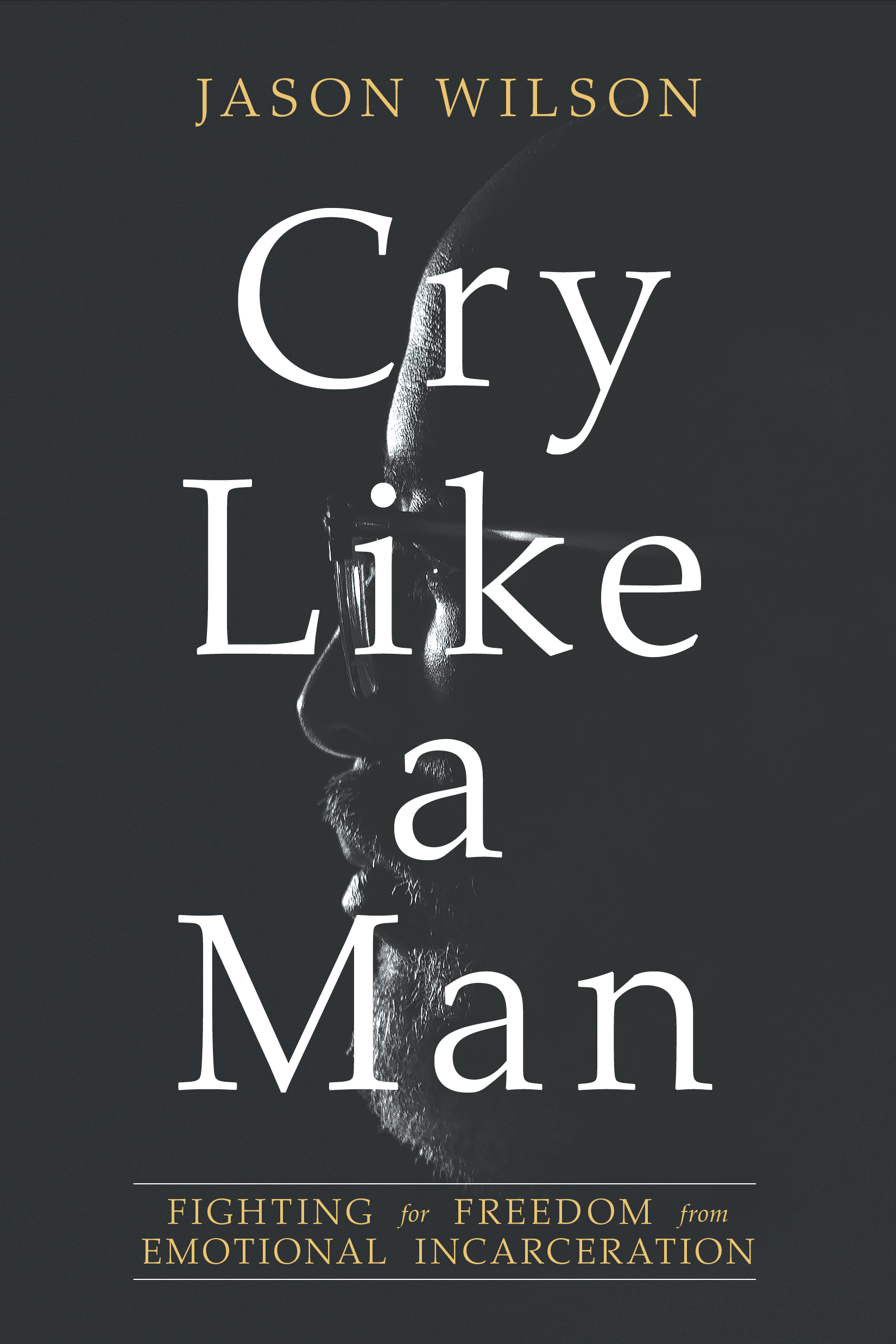
Cry Like a Man In this powerful, message-driven memoir, Jason Wilson uses his life’s trials and triumphs to show men how to escape emotional incarceration and embrace true masculinity. POLITICAL SCIENCE,Censorship

The Case Against Free Speech A hard-hitting expose that shines a light on the powerful conservative forces that have waged a multi-decade battle to hijack the meaning of free speech--and how we can reclaim it. There's a critical debate taking place over one of our most treasured rights: free speech. We argue about whether it's at risk, whether college students fear it, whether neo-Nazis deserve it, and whether the government is adequately upholding it. But as P. E. Moskowitz provocatively shows in The Case Against Free Speech, the term has been defined and redefined to suit those in power, and in recent years, it has been captured by the Right to push their agenda. What's more, our investment in the First Amendment obscures an uncomfortable truth: free speech is impossible in an unequal society where a few corporations and the ultra-wealthy bankroll political movements, millions of voters are disenfranchised, and our government routinely silences critics of racism and capitalism. Weaving together history and reporting from Charlottesville, Skokie, Standing Rock, and the college campuses where student protests made national headlines, Moskowitz argues that these flash points reveal more about the state of our democracy than they do about who is allowed to say what. Our current definition of free speech replicates power while dissuading dissent, but a new ideal is emerging. In this forcefully argued, necessary corrective, Moskowitz makes the case for speech as a tool--for exposing the truth, demanding equality, and fighting for all our civil liberties. POLITICAL SCIENCE,Censorship
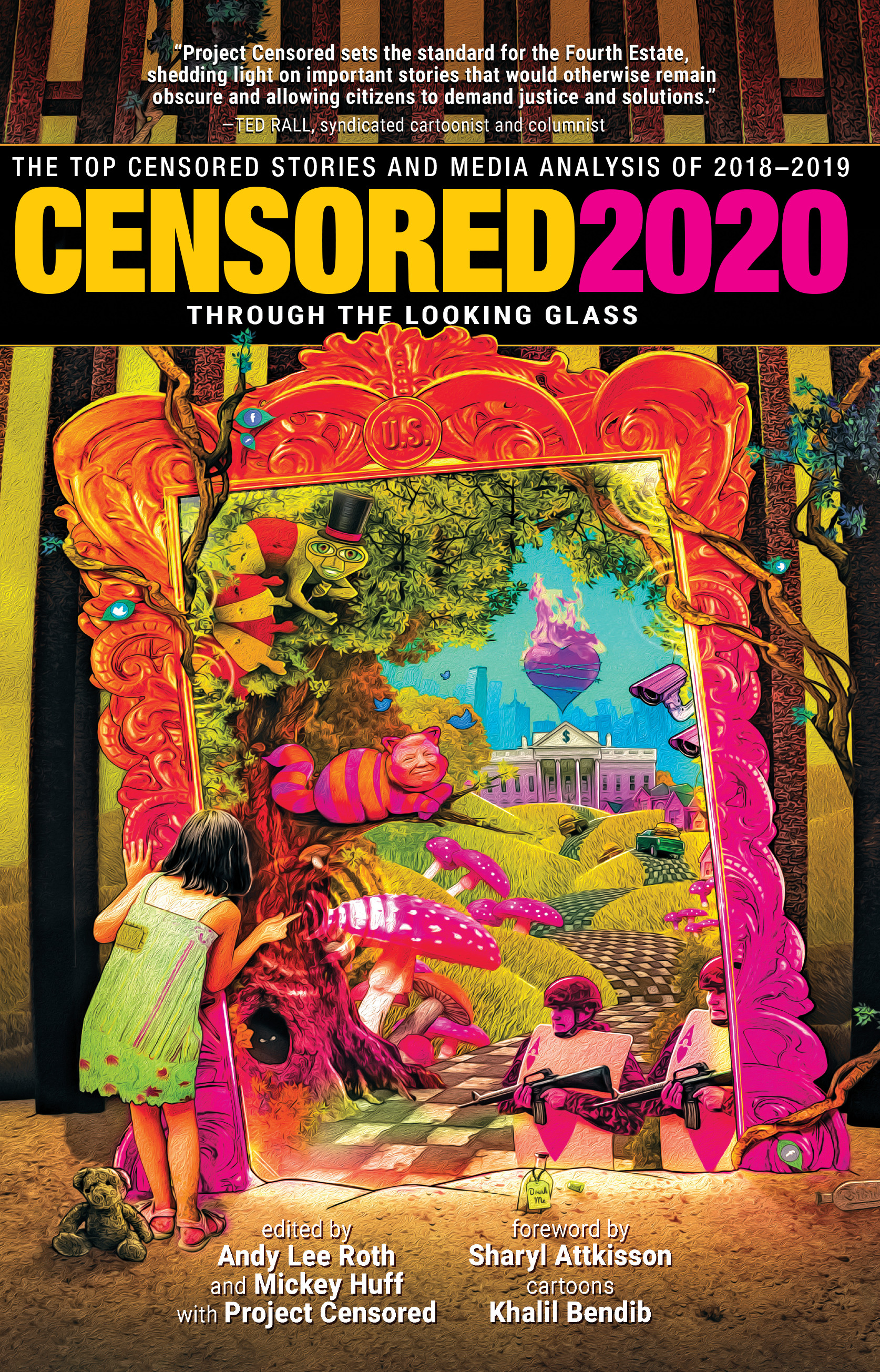
Censored 2020 In the midst of Trump's attacks on the media, comes this look at the rigorous, independent reporting of the year's most underreported news stories. While the country's president displays a brazen disregard for the First Amendment and routinely demonizes the press as "the enemy of the people," Censored 2020 looks beyond Donald Trump's dizzying contempt for the truth to clarify the corporate media's complicity in misinforming the American public--while also providing a clear vision of a better future, based on rigorous, trustworthy independent reporting that presents a fuller picture of truth. With a discerning eye, Censored 2020 focuses the public's attention on the most important but underreported news stories of 2018-2019. These stories expose the corporate news media's systemic blind spots while highlighting the crucial role played by independent journalists in providing the kind of news necessary for informed, engaged citizens. The book also examines this year's lowlights in "junk food news" and "news abuse"--further revealing how corporate news often functions as propaganda--as well as highlights of exemplary organizations that champion "Media Democracy in Action." Additional chapters address the importance of constructive journalism, the untold story of Kashmir, news coverage of LGBTQ issues in the Trump era, "fake news" as a Trojan horse for censorship, and online memes as aform of political communication. POLITICAL SCIENCE,Censorship

The Trials of Portnoy Fifty years after the event, here is the first full account of an audacious publishing decision that — with the help of booksellers and readers around the country — forced the end of literary censorship in Australia. For more than seventy years, a succession of politicians, judges, and government officials in Australia worked in the shadows to enforce one of the most pervasive and conservative regimes of censorship in the world. The goal was simple: to keep Australia free of the moral contamination of impure literature. Under the censorship regime, books that might damage the morals of the Australian public were banned, seized, and burned; bookstores were raided; publishers were fined; and writers were charged and even jailed. But in the 1970s, that all changed. In 1970, in great secrecy and at considerable risk, Penguin Books Australia resolved to publish Portnoy’s Complaint — Philip Roth’s frank, funny, and profane bestseller about a boy hung up about his mother and his penis. In doing so, Penguin spurred a direct confrontation with the censorship authorities, which culminated in criminal charges, police raids, and an unprecedented series of court trials across the country. Sweeping from the cabinet room to the courtroom, The Trials of Portnoy draws on archival records and new interviews to show how Penguin and a band of writers, booksellers, academics, and lawyers determinedly sought for Australians the freedom to read what they wished — and how, in defeating the forces arrayed before them, they reshaped Australian literature and culture forever. POLITICAL SCIENCE,Censorship
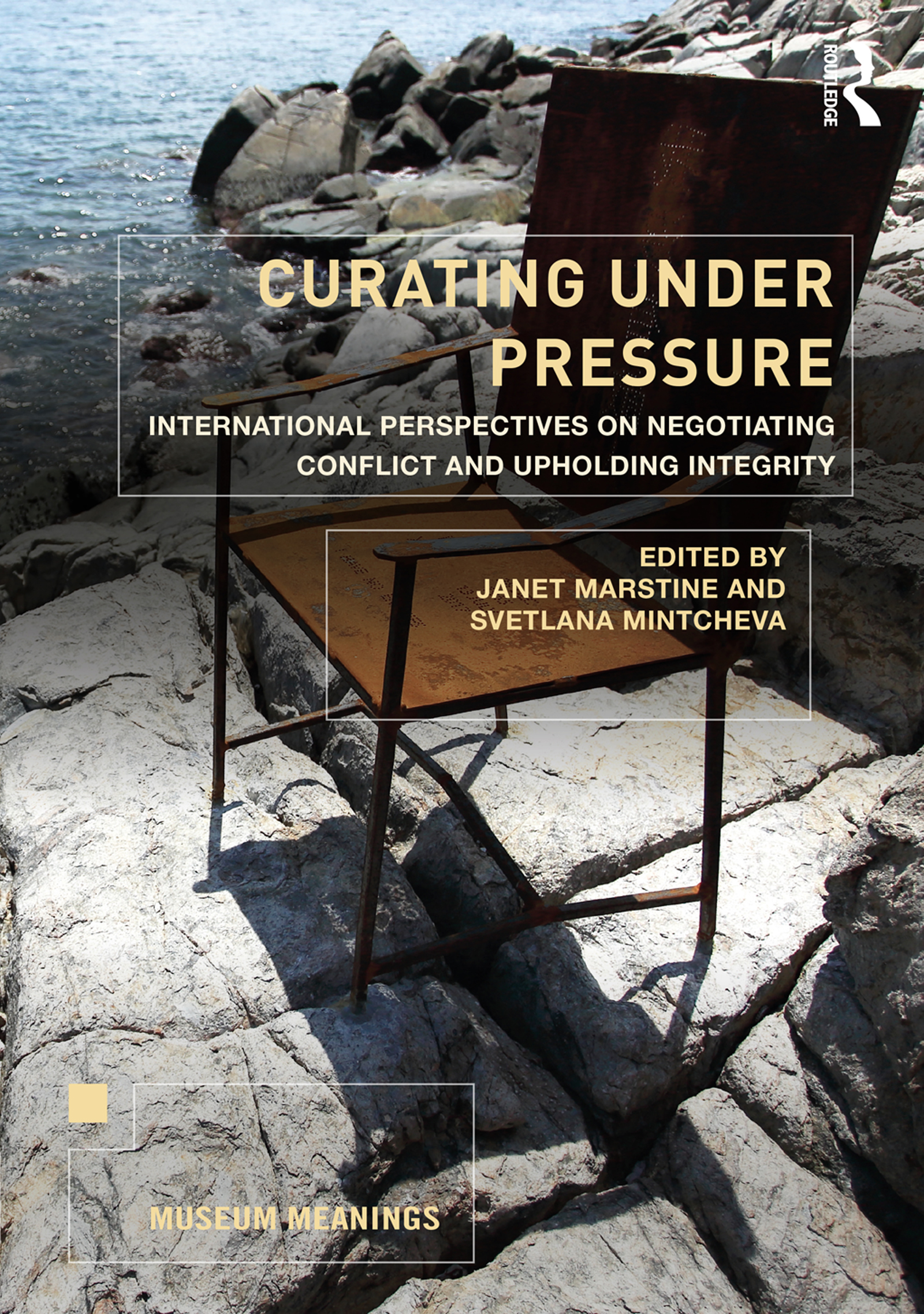
Curating Under Pressure Curating Under Pressure breaks the silence surrounding curatorial self-censorship and shows that it is both endemic to the practice and ubiquitous. Contributors map the diverse forms such self-censorship takes and offer creative strategies for negotiating curatorial integrity. This is the first book to look at pressures to self-censor and the curatorial responses to these pressures from a wide range of international perspectives. The book offers examples of the many creative strategies that curators deploy to negotiate pressures to self-censor and gives evidence of curators’ political acumen, ethical sagacity and resilience over the long term. It also challenges the assumption that self-censorship is something to be avoided at all costs and suggests that a decision to self-censor may sometimes be politically and ethically imperative. Curating Under Pressure serves as a corrective to the assumption that censorship pressures render practitioners impotent. It demonstrates that curatorial practice under pressure offers inspiring models of agency, ingenuity and empowerment. Curating Under Pressure is a highly original and intellectually ambitious volume and as such will be of great interest to students and academics in the areas of museum studies, curatorial and gallery studies, art history, studio art and arts administration. The book will also be an essential tool for museum practitioners. POLITICAL SCIENCE,Censorship
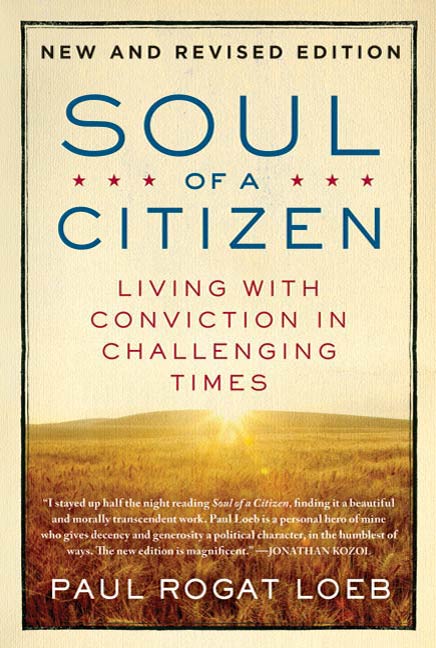
Soul of a Citizen Soul of a Citizen awakens within us the desire and the ability to make our voices heard and our actions count. We can lead lives worthy of our convictions. A book of inspiration and integrity, Soul of a Citizen is an antidote to the twin scourges of modern life--powerlessness and cynicism. In his evocative style, Paul Loeb tells moving stories of ordinary Americans who have found unexpected fulfillment in social involvement. Through their example and Loeb's own wise and powerful lessons, we are compelled to move from passivity to participation. The reward of our action, we learn, is nothing less than a sense of connection and purpose not found in a purely personal life. Soul of a Citizen has become the handbook for budding social activists, veteran organizers, and anybody who wants to make a change—big or small—in the world around them. At this critical historical time , Paul Loeb's completely revised edition—and inspiring message—is more urgently important than ever. POLITICAL SCIENCE,Civics & Citizenship
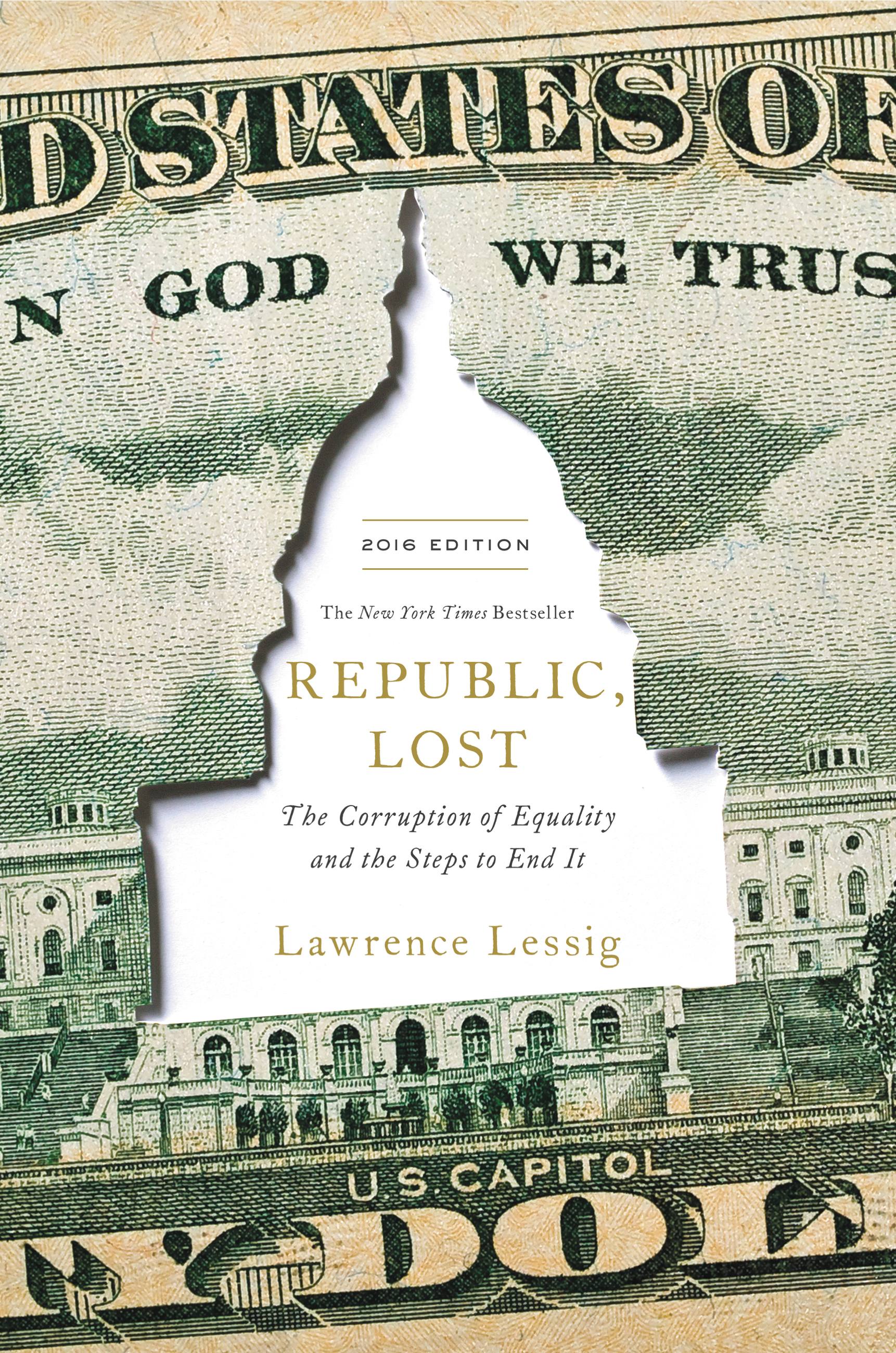
Republic, Lost In an era when special interests funnel huge amounts of money into our government-driven by shifts in campaign-finance rules and brought to new levels by the Supreme Court in Citizens United v. Federal Election Commission-trust in our government has reached an all-time low. More than ever before, Americans believe that money buys results in Congress, and that business interests wield control over our legislature. With heartfelt urgency and a keen desire for righting wrongs, Harvard law professor Lawrence Lessig takes a clear-eyed look at how we arrived at this crisis: how fundamentally good people, with good intentions, have allowed our democracy to be co-opted by outside interests, and how this exploitation has become entrenched in the system. Rejecting simple labels and reductive logic-and instead using examples that resonate as powerfully on the Right as on the Left-Lessig seeks out the root causes of our situation. He plumbs the issues of campaign financing and corporate lobbying, revealing the human faces and follies that have allowed corruption to take such a foothold in our system. He puts theissues in terms that nonwonks can understand, using real-world analogies and real human stories. And ultimately he calls for widespread mobilization and a new Constitutional Convention, presenting achievable solutions for regaining control of our corrupted-but redeemable-representational system. In this way, Lessig plots a roadmap for returning our republic to its intended greatness. While America may be divided, Lessig vividly champions the idea that we can succeed if we accept that corruption is our common enemy and that we must find a way to fight against it. In Republic Lost, he not only makes this need palpable and clear-he gives us the practical and intellectual tools to do something about it. POLITICAL SCIENCE,Civics & Citizenship

In Pursuit of Justice Ralph Nader is one of America’s most controversial—and uncompromising— public figures. He is a man on a mission who believes that taking on the powers that be involves more than just talking about it—it also means taking action. From car safety in the 1960s to opposition to the World Trade Organization in the 1990s, Nader’s work has increased government responsiveness to citizens, served as a check against the abuse of power by big business, and shaped the political consciousness of a nation. Nader’s sense of mission is infused in all of his work, especially his weekly columns. In Pursuit of Justice, a collection of Nader’s most recent, trenchant articles written in the years immediately following the publication of The Ralph Nader Reader, Nader addresses a broad array of issues, among them: corporate crime and power, government accountability, media control, consumer rights, healthcare, congressional reform, nuclear power and energy, racial discrimination, poverty, food and drug safety, air and water pollution, fair taxation, product liability protection, union democracy, living family wage, unfair lending practices, community radio, industrial hemp, banking, pension law, telecommunications and the importance of character. Nader has even sponsored consumer initiatives to reform university governance, educational testing, daily newspapers, women's health care, legal services, and professional sports—all of which are reflected in these sharp and sometimes humorous essays. As informative as it is pleasurable to read, section after section of In Pursuit of Justice slices through government and corporate propaganda and reveals the corruption, bias and injustice that all too often connect politics with big business, thereby impeding the pursuit of justice. Collecting more than one hundred of his most recent writings, In Pursuit of Justice conveys Nader's inimitable sense of both the global political economy and our nation's democratic promise. POLITICAL SCIENCE,Civics & Citizenship

Twilight of American Sanity “Unravel[s] the national psyche that brought our politics to this moment.†— Evan Osnos, The New Yorker A landmark book, from “one of the world’s most prominent psychiatrists†(The Atlantic): Allen Frances analyzes the nation, viewing the rise of Donald J. Trump as darkly symptomatic of a deeper societal distress that must be understood if we are to move forward. Equally challenging and profound, Twilight of American Sanity “joins a small shelf of essential titles—Arlie Hochschild’s Strangers in Their Own Land is another—that help explain why and how the Trump presidency happened†(Kirkus). It is comforting to see President Donald Trump as a crazy man, a one-off, an exception—not a reflection on us or our democracy. But in ways I never anticipated, his rise was absolutely predictable and a mirror on our soul. … What does it say about us, that we elected someone so manifestly unfit and unprepared to determine mankind’s future? Trump is a symptom of a world in distress, not its sole cause. Blaming him for all our troubles misses the deeper, underlying societal sickness that made possible his unlikely ascent. Calling Trump crazy allows us to avoid confronting the craziness in our society—if we want to get sane, we must first gain insight about ourselves. Simply put: Trump isn’t crazy, but our society is. —from TWILIGHT OF AMERICAN SANITY More than three years in the making: the world's leading expert on psychiatric diagnosis, past leader of the American Psychiatric Association’s DSM (“the bible of psychologyâ€), and author of the influential international bestseller on the medicalization of ordinary life, Saving Normal, draws upon his vast experience to deliver a powerful critique of modern American society’s collective slide away from sanity and offers an urgently needed prescription for reclaiming our bearings. Widely cited in recent months as the man who quite literally wrote the diagnostic criteria for narcissism, Allen Frances, M.D., has been at the center of the debate surrounding President Trump’s mental state—quoted in Evan Osnos’s May 2017 New Yorker article (“How Trump Could Get Firedâ€) and publishing a much-shared opinion letter in the New York Times (“An Eminent Psychiatrist Demurs on Trump’s Mental Stateâ€). Frances argues that Trump is "bad, not mad"--and that the real question to wrestle with is how we as a country could have chosen him as our leader. Twilight of American Sanity is an essential work for understanding our national crisis. POLITICAL SCIENCE,Civics & Citizenship

How Civility Works Is civility dead? Americans ask this question every election season, but their concern is hardly limited to political campaigns. Doubts about civility regularly arise in just about every aspect of American public life. Rudeness runs rampant. Our news media is saturated with aggressive bluster and vitriol. Our digital platforms teem with trolls and expressions of disrespect. Reflecting these conditions, surveys show that a significant majority of Americans believe we are living in an age of unusual anger and discord. Everywhere we look, there seems to be conflict and hostility, with shared respect and consideration nowhere to be found. In a country that encourages thick skins and speaking one's mind, is civility even possible, let alone desirable? In How Civility Works, Keith J. Bybee elegantly explores the "crisis" in civility, looking closely at how civility intertwines with our long history of boorish behavior and the ongoing quest for pleasant company. Bybee argues that the very features that make civility ineffective and undesirable also point to civility's power and appeal. Can we all get along? If we live by the contradictions on which civility depends, then yes, we can, and yes, we should. POLITICAL SCIENCE,Civics & Citizenship
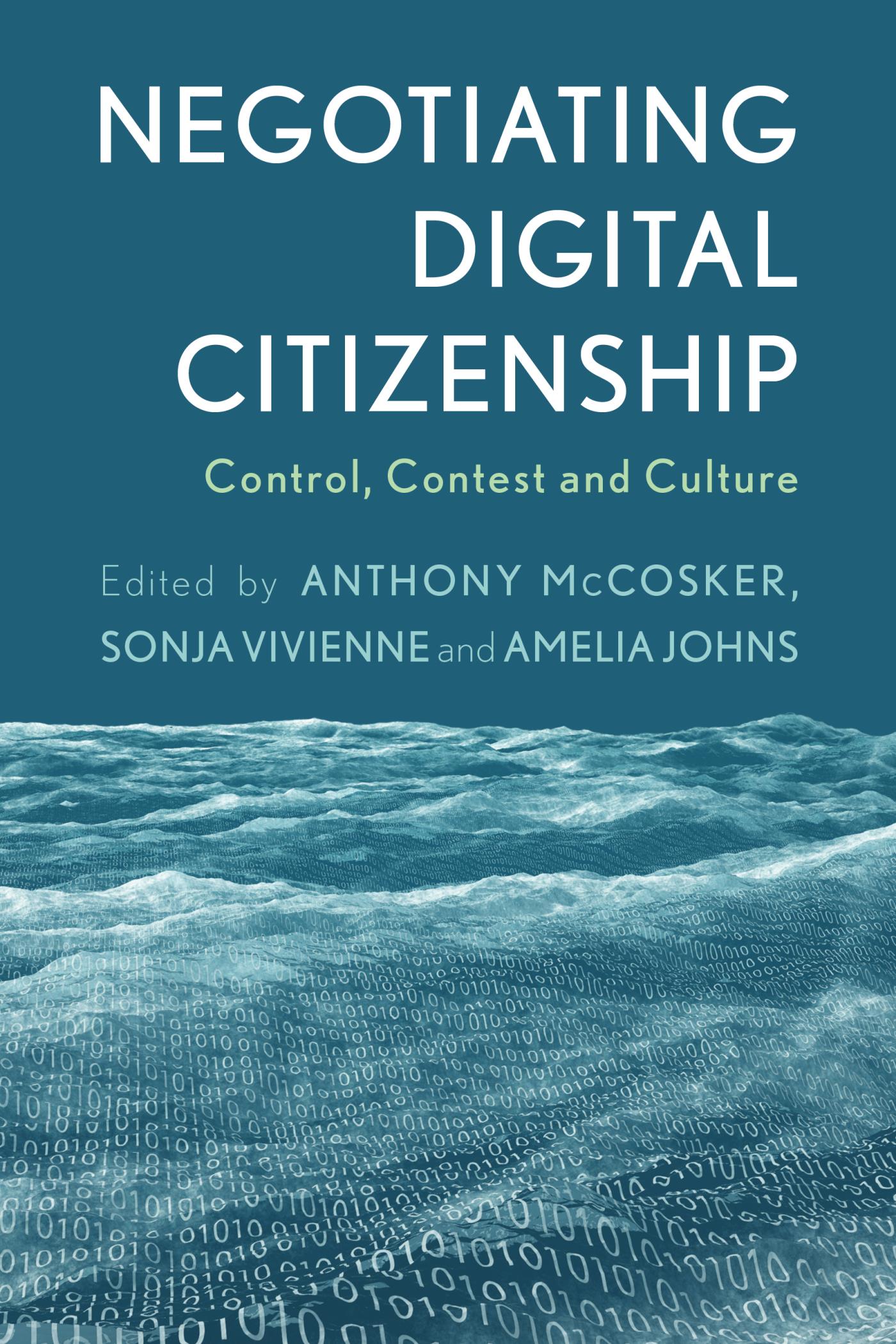
Negotiating Digital Citizenship This book challenges the assumptions behind the idea of digital citizenship in order to turn the attention to cases of innovation, social change and public good. POLITICAL SCIENCE,Civics & Citizenship

On Tyranny #1 New York Times Bestseller • A historian of fascism offers a guide for surviving and resisting America's turn towards authoritarianism. The Founding Fathers tried to protect us from the threat they knew, the tyranny that overcame ancient democracy. Today, our political order faces new threats, not unlike the totalitarianism of the twentieth century. We are no wiser than the Europeans who saw democracy yield to fascism, Nazism, or communism. Our one advantage is that we might learn from their experience. On Tyranny is a call to arms and a guide to resistance, with invaluable ideas for how we can preserve our freedoms in the uncertain years to come. "Mr. Snyder is a rising public intellectual unafraid to make bold connections between past and present." —The New York Times POLITICAL SCIENCE,Civics & Citizenship
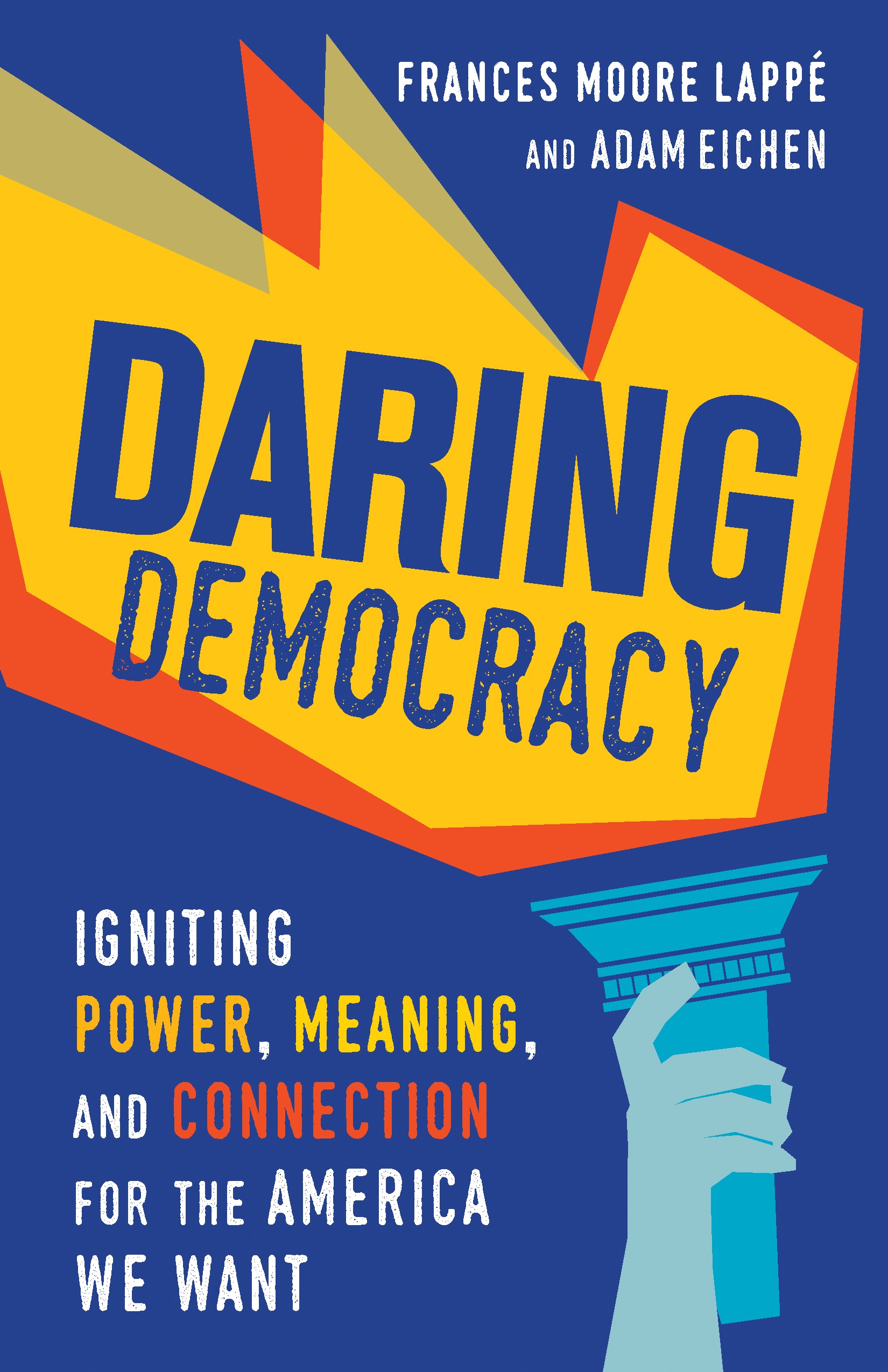
Daring Democracy An optimistic book for Americans who are asking, in the wake of Trump’s victory, What do we do now? The answer: We need to organize and fight to protect and expand our democracy. Americans are distraught as tightly held economic and political power drowns out their voices and values. Legendary Diet for a Small Planet author Frances Moore Lappé and organizer-scholar Adam Eichen offer a fresh, surprising response to this core crisis. This intergenerational duo opens with an essential truth: It’s not the magnitude of a challenge that crushes the human spirit. It’s feeling powerless—in this case, fearing that to stand up for democracy is futile. It’s not, Lappé and Eichen argue. With riveting stories and little-known evidence, they demystify how we got here, exposing the well-orchestrated effort that has robbed Americans of their rightful power. But at the heart of this unique book are solutions. Even in this divisive time, Americans are uniting across causes and ideologies to create a “canopy of hope” the authors call the Democracy Movement. In this invigorating “movement of movements,” millions of Americans are leaving despair behind as they push for and achieve historic change. The movement and democracy itself are vital to us as citizens and fulfill human needs—for power, meaning, and connection—essential to our thriving. In this timely and necessary book, Lappé and Eichen offer proof that courage is contagious in the daring fight for democracy. POLITICAL SCIENCE,Civics & Citizenship
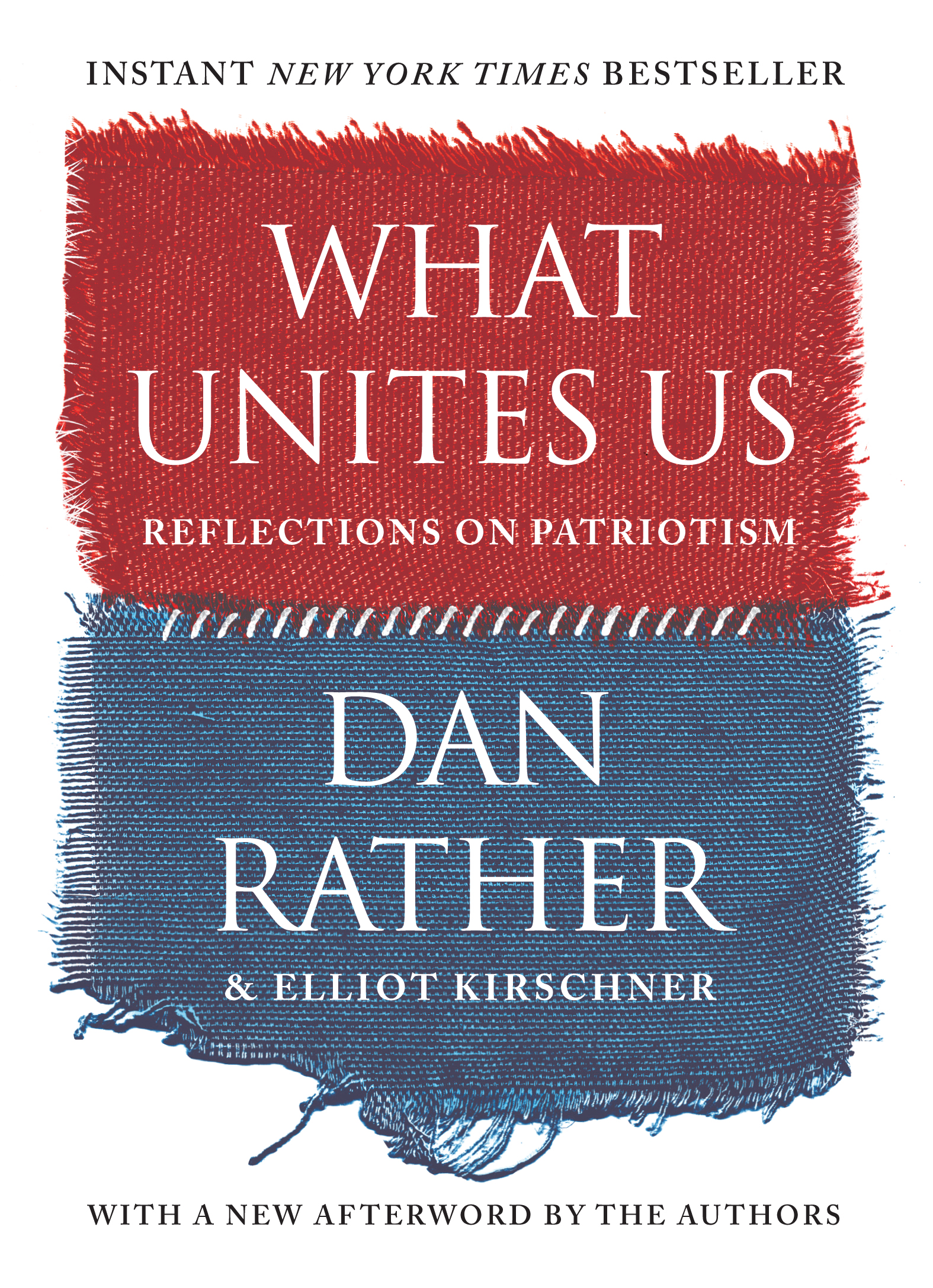
What Unites Us AN INSTANT NEW YORK TIMES BESTSELLER “I find myself thinking deeply about what it means to love America, as I surely do.” —Dan Rather At a moment of crisis over our national identity, venerated journalist Dan Rather has emerged as a voice of reason and integrity, reflecting on—and writing passionately about—what it means to be an American. Now, with this collection of original essays, he reminds us of the principles upon which the United States was founded. Looking at the freedoms that define us, from the vote to the press; the values that have transformed us, from empathy to inclusion to service; the institutions that sustain us, such as public education; and the traits that helped form our young country, such as the audacity to take on daunting challenges in science and medicine, Rather brings to bear his decades of experience on the frontlines of the world’s biggest stories. As a living witness to historical change, he offers up an intimate view of history, tracing where we have been in order to help us chart a way forward and heal our bitter divisions. With a fundamental sense of hope, What Unites Us is the book to inspire conversation and listening, and to remind us all how we are, finally, one. POLITICAL SCIENCE,Civics & Citizenship
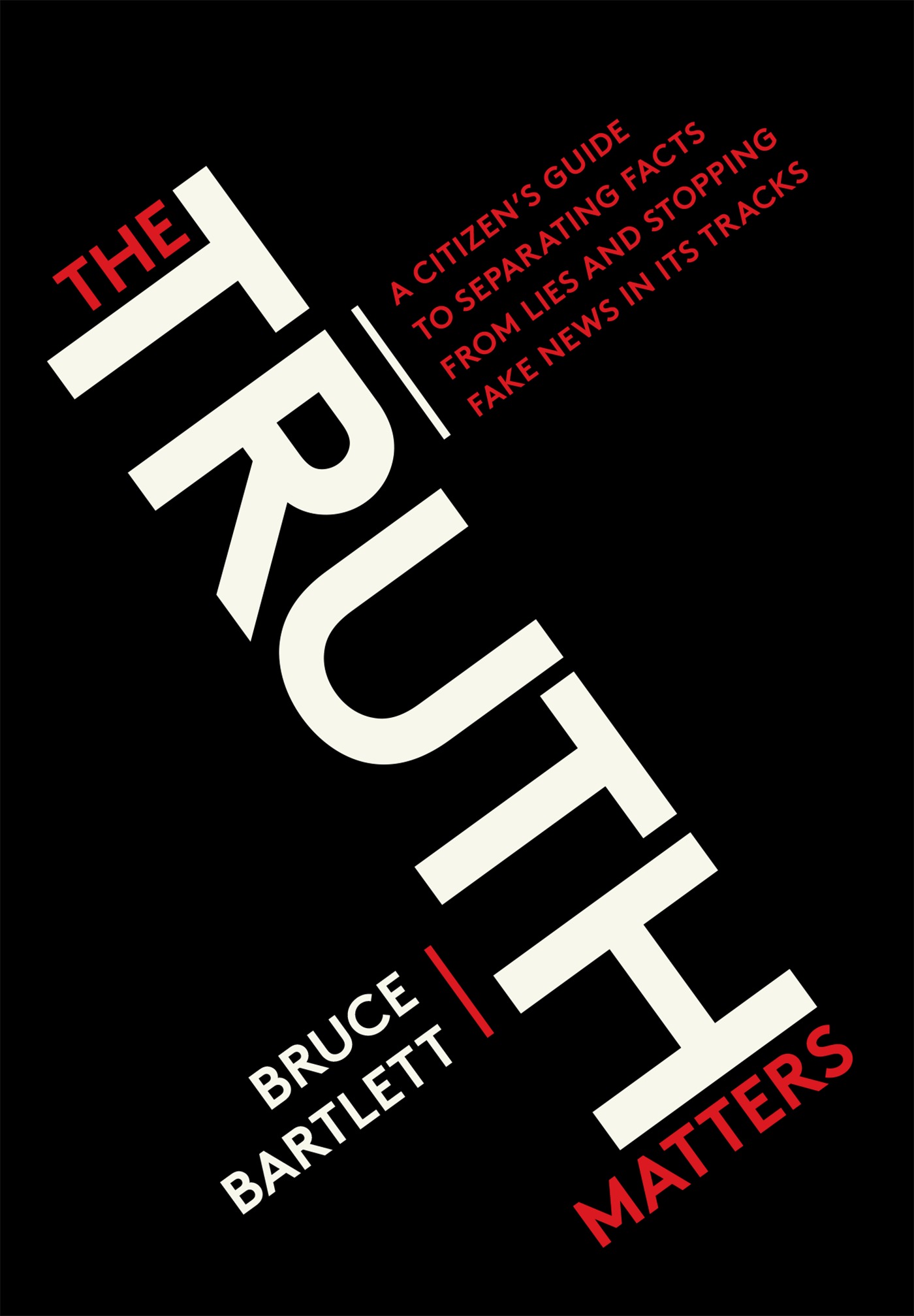
The Truth Matters Distinguish fake news from reliable journalism with this clear and concise handbook by New York Times best-selling author Bruce Bartlett. Today’s media and political landscapes are littered with untrustworthy sources and the dangerous concept of “fake news.” This accessible guide helps you fight this deeply troubling trend and ensure that truth is not a permanent casualty. Written by Capitol Hill veteran and author Bruce Bartlett, The Truth Matters presents actionable tips and tricks for reading critically, judging sources, using fact-checking sites, avoiding confirmation bias, identifying trustworthy experts, and more. POLITICAL SCIENCE,Civics & Citizenship

The Death of Truth NEW YORK TIMES BESTSELLER NEW YORK TIMES Editors' Choice From the Pulitzer Prize-winning critic comes an impassioned critique of America’s retreat from reason We live in a time when the very idea of objective truth is mocked and discounted by the occupants of the White House. Discredited conspiracy theories and ideologies have resurfaced, proven science is once more up for debate, and Russian propaganda floods our screens. The wisdom of the crowd has usurped research and expertise, and we are each left clinging to the beliefs that best confirm our biases. How did truth become an endangered species in contemporary America? This decline began decades ago, and in The Death of Truth, former New York Times critic Michiko Kakutani takes a penetrating look at the cultural forces that contributed to this gathering storm. In social media and literature, television, academia, and politics, Kakutani identifies the trends—originating on both the right and the left—that have combined to elevate subjectivity over factuality, science, and common values. And she returns us to the words of the great critics of authoritarianism, writers like George Orwell and Hannah Arendt, whose work is newly and eerily relevant. With remarkable erudition and insight, Kakutani offers a provocative diagnosis of our current condition and points toward a new path for our truth-challenged times. POLITICAL SCIENCE,Civics & Citizenship

Anchor Babies and the Challenge of Birthright Citizenship Birthright citizenship has a deep and contentious history in the United States, one often hard to square in a country that prides itself on being "a nation of immigrants." Even as the question of citizenship for children of immigrants was seemingly settled by the Fourteenth Amendment, vitriolic debate has continued for well over a century, especially in relation to U.S. race relations. Most recently, a provocative and decidedly more offensive term than birthright citizenship has emerged: "anchor babies." With this book, Leo R. Chavez explores the question of birthright citizenship, and of citizenship in the United States writ broadly, as he counters the often hyperbolic claims surrounding these so-called anchor babies. Chavez considers how the term is used as a political dog whistle, how changes in the legal definition of citizenship have affected the children of immigrants over time, and, ultimately, how U.S.-born citizens still experience trauma if they live in families with undocumented immigrants. By examining this pejorative term in its political, historical, and social contexts, Chavez calls upon us to exorcise it from public discourse and work toward building a more inclusive nation. POLITICAL SCIENCE,Civics & Citizenship
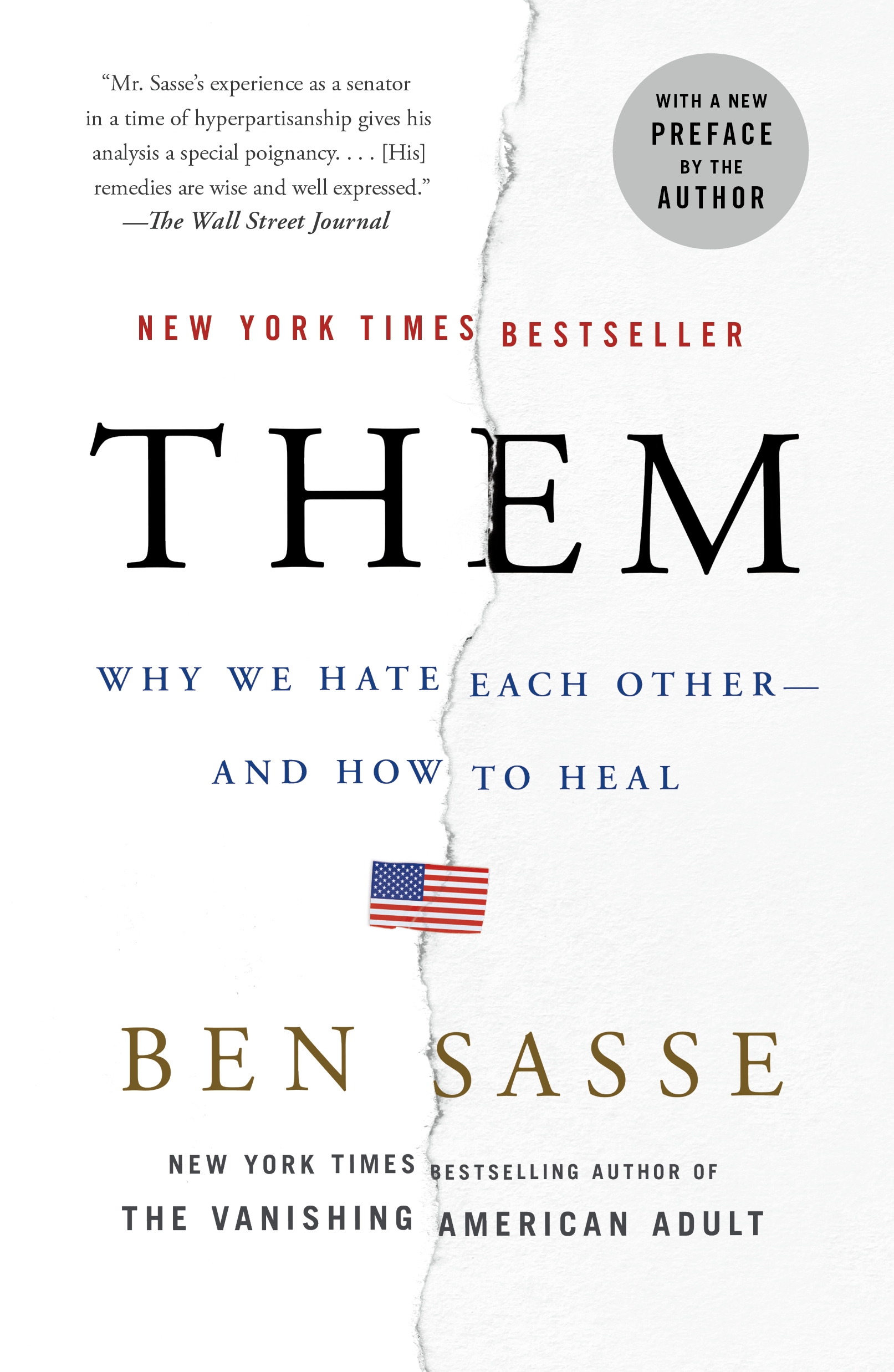
Them * AN INSTANT NEW YORK TIMES BESTSELLER * From the New York Times bestselling author of The Vanishing American Adult , an intimate and urgent assessment of the existential crisis facing our nation. Something is wrong. We all know it. American life expectancy is declining for a third straight year. Birth rates are dropping. Nearly half of us think the other political party isn’t just wrong; they’re evil. We’re the richest country in history, but we’ve never been more pessimistic. What’s causing the despair? In Them, bestselling author and U.S. senator Ben Sasse argues that, contrary to conventional wisdom, our crisis isn’t really about politics. It’s that we’re so lonely we can’t see straight—and it bubbles out as anger. Local communities are collapsing. Across the nation, little leagues are disappearing, Rotary clubs are dwindling, and in all likelihood, we don’t know the neighbor two doors down. Work isn’t what we’d hoped: less certainty, few lifelong coworkers, shallow purpose. Stable families and enduring friendships—life’s fundamental pillars—are in statistical freefall. As traditional tribes of place evaporate, we rally against common enemies so we can feel part of a team. No institutions command widespread public trust, enabling foreign intelligence agencies to use technology to pick the scabs on our toxic divisions. We’re in danger of half of us believing different facts than the other half, and the digital revolution throws gas on the fire. There’s a path forward—but reversing our decline requires something radical: a rediscovery of real places and human-to-human relationships. Even as technology nudges us to become rootless, Sasse shows how only a recovery of rootedness can heal our lonely souls. America wants you to be happy, but more urgently, America needs you to love your neighbor and connect with your community. Fixing what's wrong with the country depends on it. POLITICAL SCIENCE,Civics & Citizenship
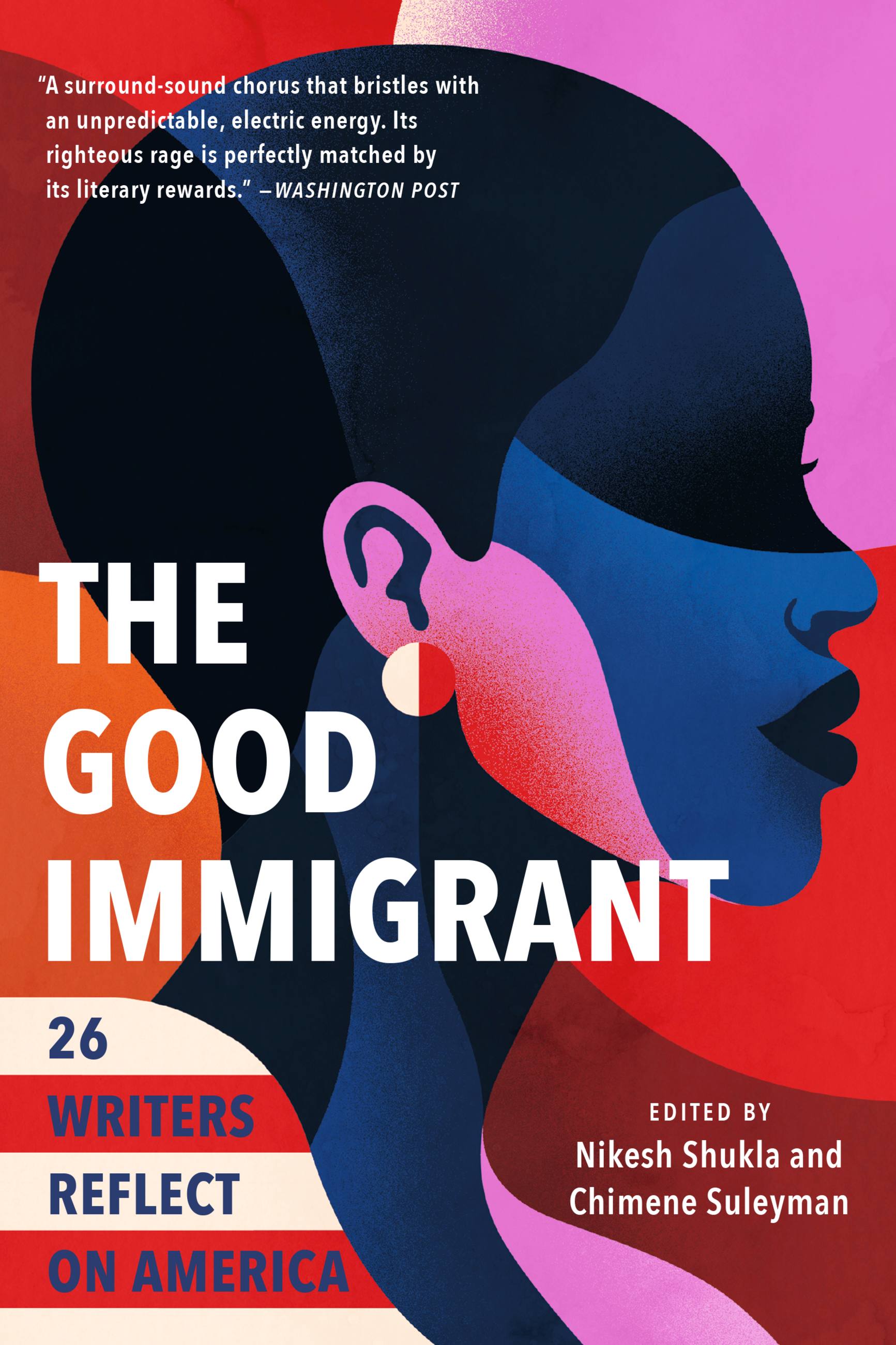
The Good Immigrant By turns heartbreaking and hilarious, troubling and uplifting, these "electric" essays come together to create a provocative, conversation-sparking, multivocal portrait of modern America (The Washington Post). From Trump's proposed border wall and travel ban to the marching of white supremacists in Charlottesville, America is consumed by tensions over immigration and the question of which bodies are welcome. In this much-anticipated follow-up to the bestselling UK edition, hailed by Zadie Smith as "lively and vital," editors Nikesh Shukla and Chimene Suleyman hand the microphone to an incredible range of writers whose humanity and right to be here is under attack. Chigozie Obioma unpacks an Igbo proverb that helped him navigate his journey to America from Nigeria. Jenny Zhang analyzes cultural appropriation in 90s fashion, recalling her own pain and confusion as a teenager trying to fit in. Fatimah Asghar describes the flood of memory and emotion triggered by an encounter with an Uber driver from Kashmir. Alexander Chee writes of a visit to Korea that changed his relationship to his heritage. These writers, and the many others in this urgent collection, share powerful personal stories of living between cultures and languages while struggling to figure out who they are and where they belong. POLITICAL SCIENCE,Civics & Citizenship

Institutional Racism, Organizations & Public Policy Institutional racism may be described as a self-perpetuating and opaque process where, either intentionally or unintentionally, barriers and procedures which disadvantage ethnic minority groups are supported and maintained. It is often the direct linkage and thus the underlying cause for the lack of diversity and cultural competency in the workplace. Yet institutional racism, as a research topic, has been ignored by scholars because it forces emphasis on the unseen and unspoken, yet culturally relevant underpinnings of the workplace and societal ethos. Studies touching on diversity in the public administration research often address the subject as education and training – especially with regard to the competencies needed by professional administrators. However, racism and discrimination, as underlying factors, are seldom addressed. Once specific examples of institutional racism have been identified in an organization, change agents may take prescriptive steps to address it directly and thus have a more cogent argument for change. POLITICAL SCIENCE,Civics & Citizenship
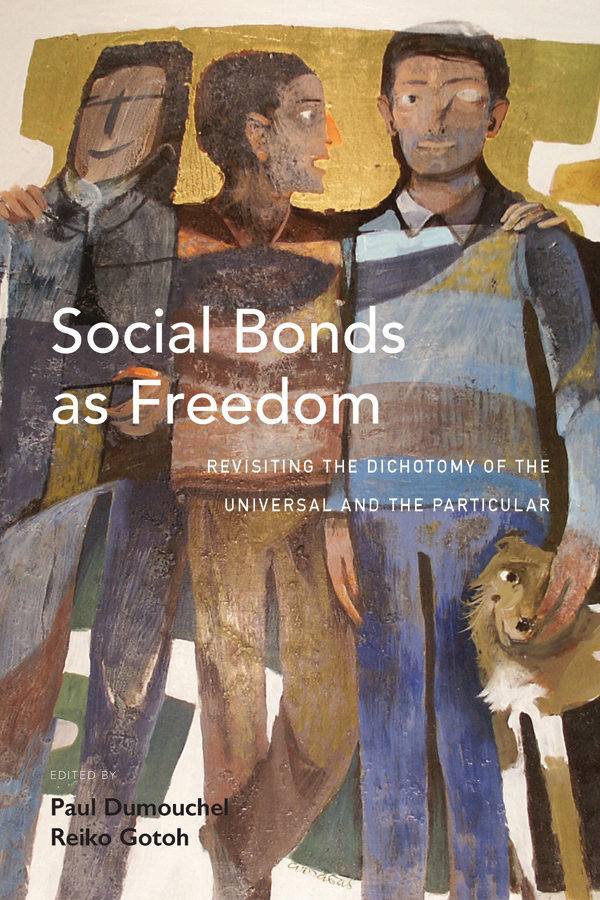
Social Bonds as Freedom Central to discussions of multiculturalism and minority rights in modern liberal societies is the idea that the particular demands of minority groups contradict the requirements of equality, anonymity, and universality for citizenship and belonging. The contributors to this volume question the significance of this dichotomy between the universal and the particular, arguing that it reflects how the modern state has instituted the basic rights and obligations of its members and that these institutions are undergoing fundamental transformations under the pressure of globalization. They show that the social bonds uniting groups constitute the means of our freedom, rather than obstacles to achieving the universal. POLITICAL SCIENCE,Civics & Citizenship
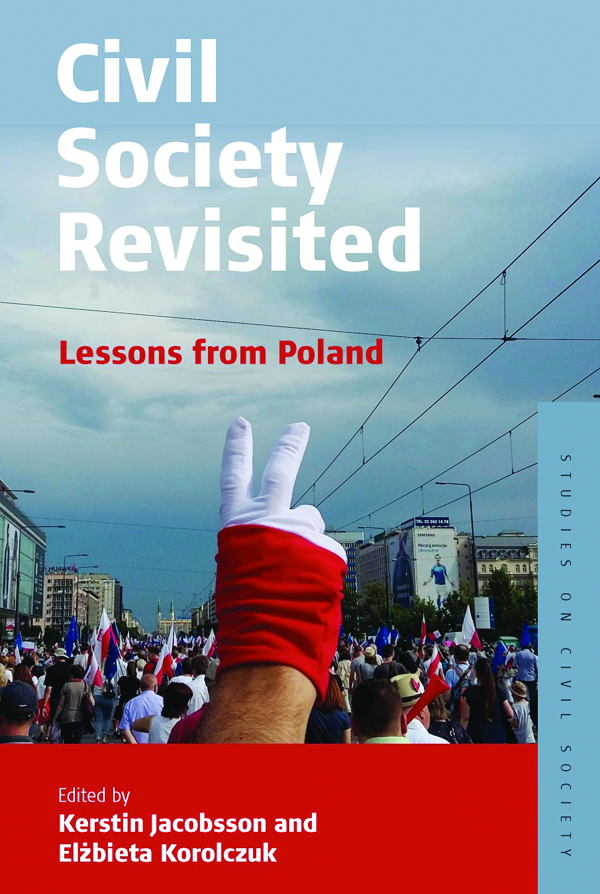
Civil Society Revisited In much social scientific literature, Polish civil society has been portrayed as weak and passive. This volume offers a much-needed corrective, challenging this characterization on both theoretical and empirical grounds and suggesting new ways of conceptualizing civil society to better account for events on the ground as well as global trends such as neoliberalism, migration, and the renewal of nationalist ideologies. Focusing on forms of collective action that researchers have tended to overlook, the studies gathered here show how public discourse legitimizes certain claims and political actions as “true†civil society, while others are too often dismissed. Taken together, they critique a model of civil society that is ‘made from above’. POLITICAL SCIENCE,Civics & Citizenship
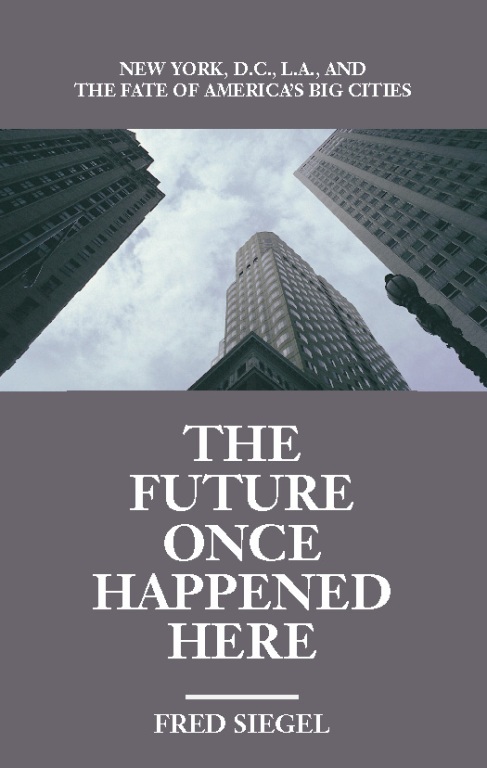
The Future Once Happened Here "In The Future Once Happened Here, Fred Siegel tells an incredible story about the fate of America’s most influential cities: New York, Washington, D.C., and Los Angeles. Standing as metaphors for America’s urban life because of their stature as nerve centers of the nation, these three citiesonce celebrated for their excitement and creativity as well as their ability to incorporate immigrants and solve the nation’s problemswere all caught up in the social policies born in the ’60s and ’70s and, as a consequence, faltered badly in dealing with the politics of race and the quality of their residents’ lives in the ’80s and ’90s. Each of Siegel’s three urban portraits shows the desperate remedies undertaken by cities searching for a lifeline back to the future whose promise they once seemed to embody. In a narrative that acknowledges the large historical forces that have remade the face of America over the last three decades, but insists that social policies are not merely foregone conclusions waiting to happen, Siegel holds up a mirror to our urban naure and tells us much about the way we live now." POLITICAL SCIENCE,Civics & Citizenship

I, the Citizen I, the Citizen is an attempt to understand citizen development and engagement. R. Balasubramaniam takes the reader through interpretations of development initiatives at the grassroots and what good governance means to ordinary people. He unravels the power of citizen engagement through his experiences of leading civil society campaigns against corruption and towards strengthening democratic participation of people. I, the Citizen also deals with the philosophical underpinnings of public policies, drawing from his on-the-ground experience as well as engagement with those in the higher echelons of policymaking and implementation. The last section of the book provides glimpses into milestones of a development movement, which Balu founded and led, milestones that are responsible for a continued faith in citizen engagement despite the hindering forces. POLITICAL SCIENCE,Civics & Citizenship

Arguing for Our Lives With public discourse more skewed than ever by big money's propaganda, our future hinges on our capacity for critical thinking. POLITICAL SCIENCE,Civics & Citizenship
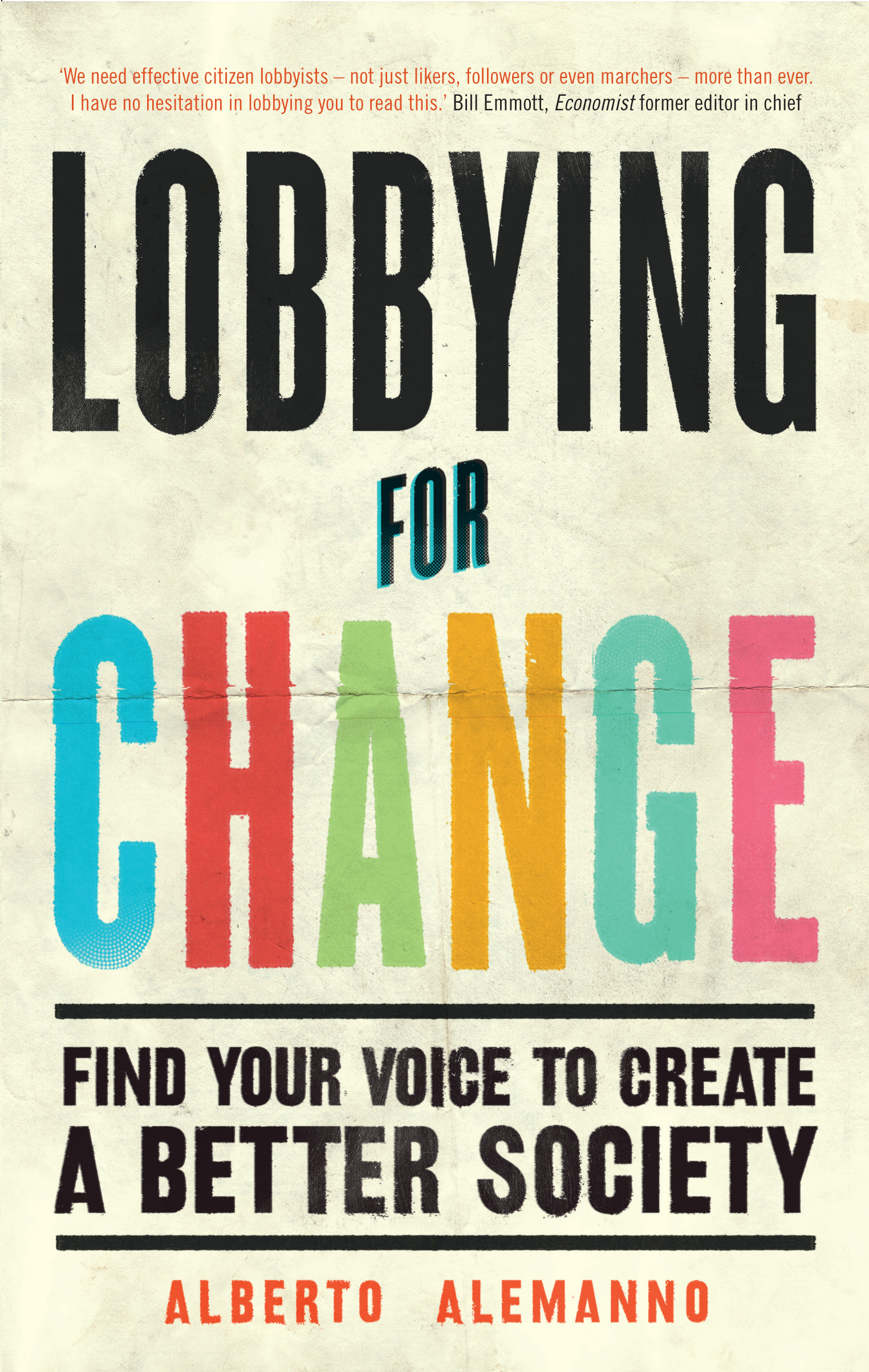
Lobbying for Change 'We need effective citizen-lobbyists – not just likers, followers or even marchers – more than ever. I have no hesitation in lobbying you to read this book.'Bill Emmott, former editor in chief, the Economist Many democratic societies are experiencing a crisis of faith. Citizens are making clear their frustration with their supposedly representative governments, which instead seem driven by the interests of big business, powerful individuals and wealthy lobby groups. What can we do about it? How do we fix democracy and get our voices heard? The answer, argues Alberto Alemanno, is to become change-makers – citizen lobbyists. By using our skills and talents and mobilizing others, we can bring about social and political change. Whoever you are, you’ve got power, and this book will show you how to unleash it. From successfully challenging Facebook’s use of private data to abolishing EU mobile phone roaming charges, Alberto highlights the stories of those who have lobbied for change, and shows how you can follow in their footsteps, whether you want to influence immigration policy, put pressure on big business or protect your local community. POLITICAL SCIENCE,Civics & Citizenship
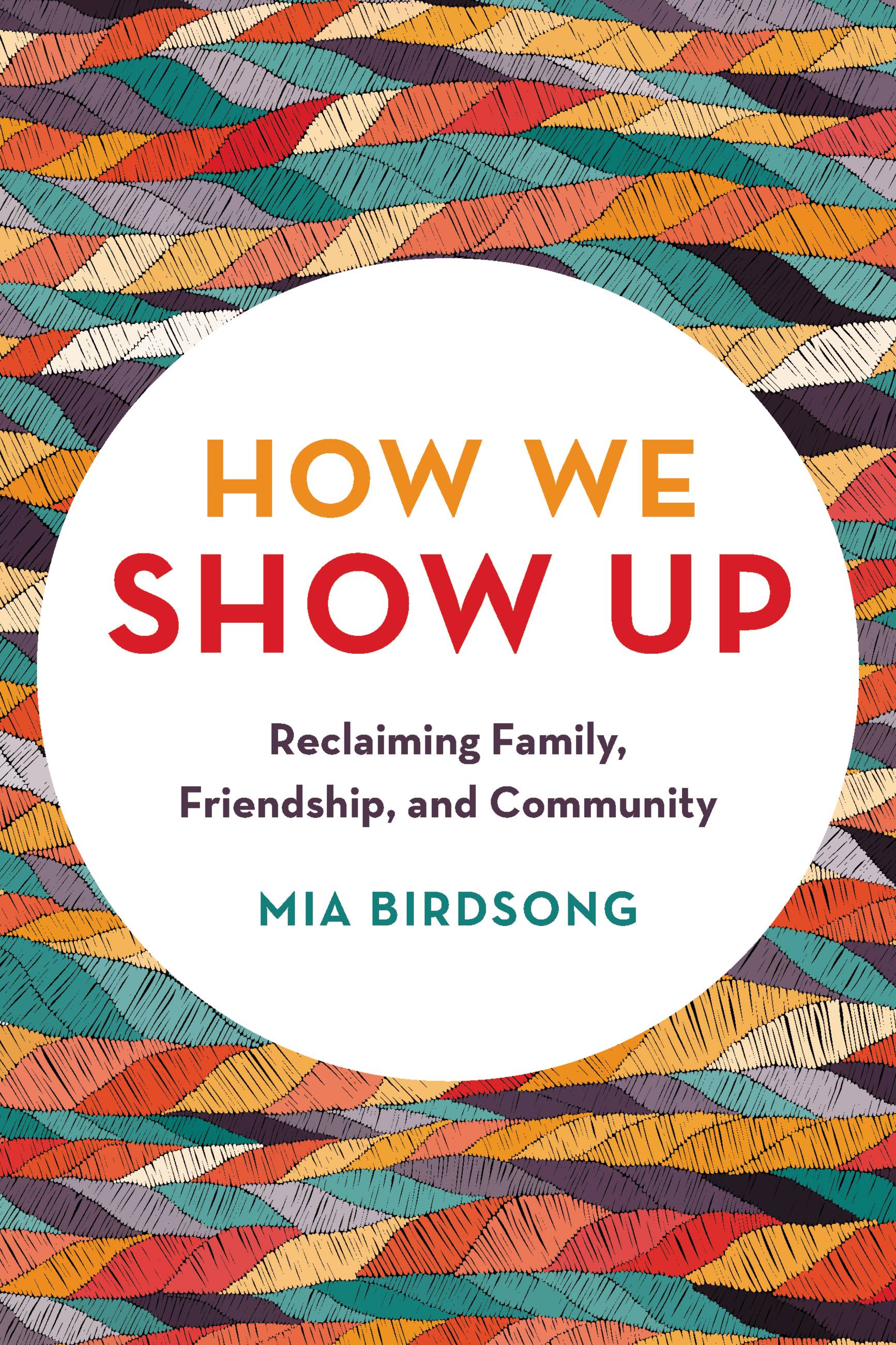
How We Show Up An Invitation to Community and Models for Connection After almost every presentation activist and writer Mia Birdsong gives to executives, think tanks, and policy makers, one of those leaders quietly confesses how much they long for the profound community she describes. They have family, friends, and colleagues, yet they still feel like they're standing alone. They're "winning" at the American Dream, but they're lonely, disconnected, and unsatisfied. It seems counterintuitive that living the "good life"--the well-paying job, the nuclear family, the upward mobility--can make us feel isolated and unhappy. But in a divided America, where only a quarter of us know our neighbors and everyone is either a winner or a loser, we've forgotten the key element that helped us make progress in the first place: community. In this provocative, groundbreaking work, Mia Birdsong shows that what separates us isn't only the ever-present injustices built around race, class, gender, values, and beliefs, but also our denial of our interdependence and need for belonging. In response to the fear and discomfort we feel, we've built walls, and instead of leaning on each other, we find ourselves leaning on concrete. Through research, interviews, and stories of lived experience, How We Show Up returns us to our inherent connectedness where we find strength, safety, and support in vulnerability and generosity, in asking for help, and in being accountable. Showing up--literally and figuratively--points us toward the promise of our collective vitality and leads us to the liberated well-being we all want. POLITICAL SCIENCE,Civics & Citizenship

Intercultural Citizenship in the Post-Multicultural Era In this concise, theoretically-focused and empirically grounded book, Zapata-Barrero outlines the foundations of the intercultural policy paradigm that is emerging within diversity and migration studies. POLITICAL SCIENCE,Civics & Citizenship
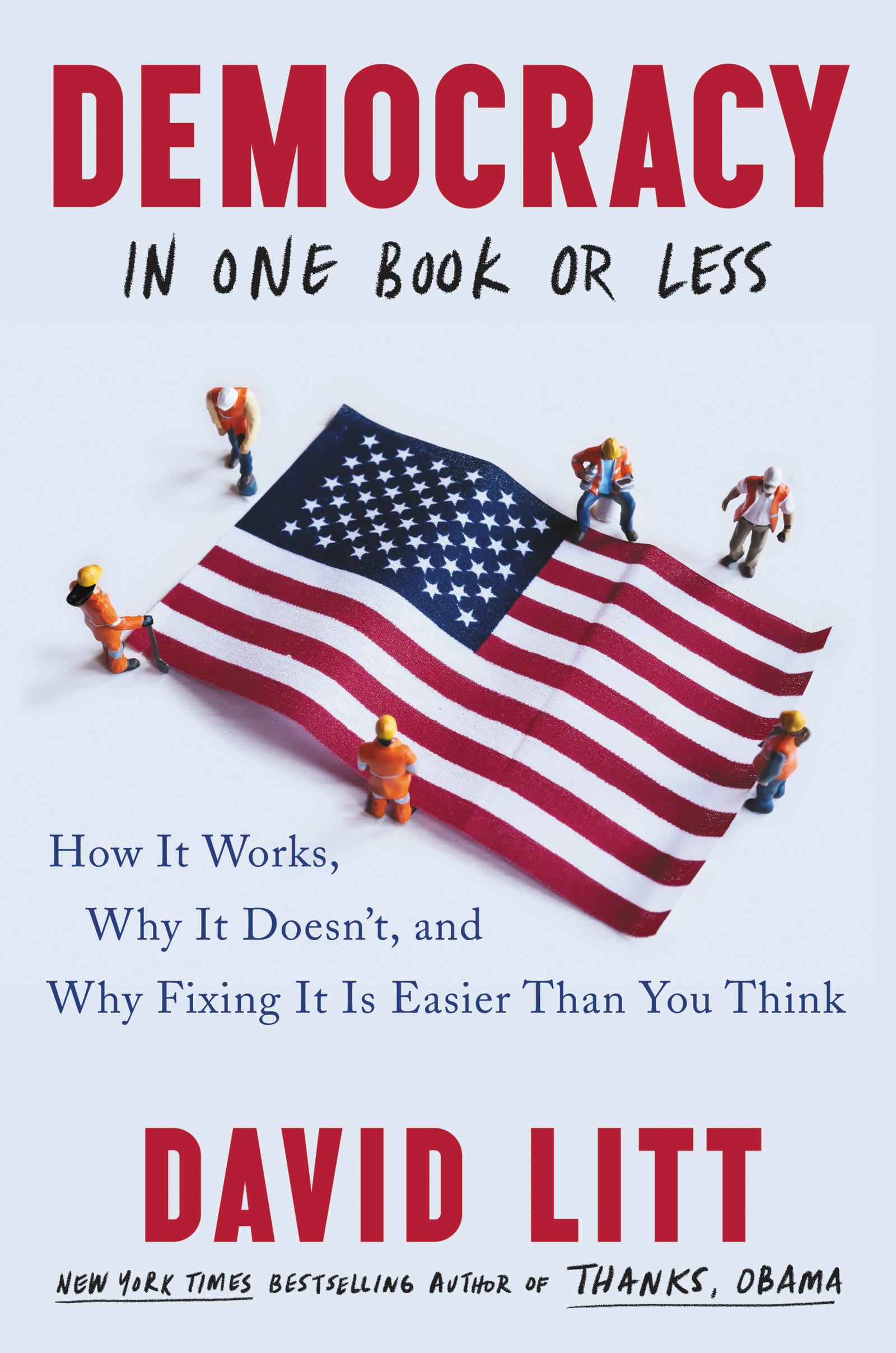
Democracy in One Book or Less Bill Bryson meets Thomas Frank in this deeply insightful, unexpectedly hilarious story of how politicians hijacked American democracy and how we can take it back The democracy you live in today is different—completely different—from the democracy you were born into. You probably don't realize just how radically your republic has been altered during your lifetime. Yet more than any policy issue, political trend, or even Donald Trump himself, our redesigned system of government is responsible for the peril America faces today. What explains the gap between what We, the People want and what our elected leaders do? How can we fix our politics before it's too late? And how can we truly understand the state of our democracy without wanting to crawl under a rock? That's what former Obama speechwriter David Litt set out to answer. Poking into forgotten corners of history, translating political science into plain English, and traveling the country to meet experts and activists, Litt explains how the world’s greatest experiment in democracy went awry. (He also tries to crash a party at Mitch McConnell’s former frat house. It goes poorly.) The result of Litt's journey is something you might not have thought possible: a page-turner about the political process. You'll meet the Supreme Court justice charged with murder, learn how James Madison's college roommate broke the Senate, encounter a citrus thief who embodies what's wrong with our elections, and join Belle the bill as she tries to become a law (a quest far more harrowing than the one in Schoolhouse Rock!). Yet despite his clear-eyed assessment of the dangers we face, Litt remains audaciously optimistic. He offers a to-do list of bold yet achievable changes—a blueprint for restoring the balance of power in America before it's too late. POLITICAL SCIENCE,Civics & Citizenship

The Marketing of Evil DAVID KUPELIAN'S CULTURE-WAR BESTSELLER IS NOW AVAILABLE IN PAPERBACK! Millions of Americans today accept ideas and behaviors that would have horrified all previous generations. Why? Why have thousands of years of Judeo-Christian moral standards suddenly been abandoned? What's behind today's divorce epidemic? Why is public prayer being criminalized? Why are 3,000 innocent unborn children aborted daily? In this widely acclaimed exposé, veteran journalist David Kupelian reveals the brilliant marketing strategies that have turned America upside down. "Within the space of our lifetime, much of what Americans once almost universally abhorred has been packaged, perfumed, gift-wrapped, and sold to us as though it had great value. By skillfully playing on our deeply felt national values of fairness, generosity, and tolerance, these marketers have persuaded us to embrace as enlightened and noble that which every other generation has regarded as grossly self-destructive—in a word, evil.†POLITICAL SCIENCE,Civics & Citizenship
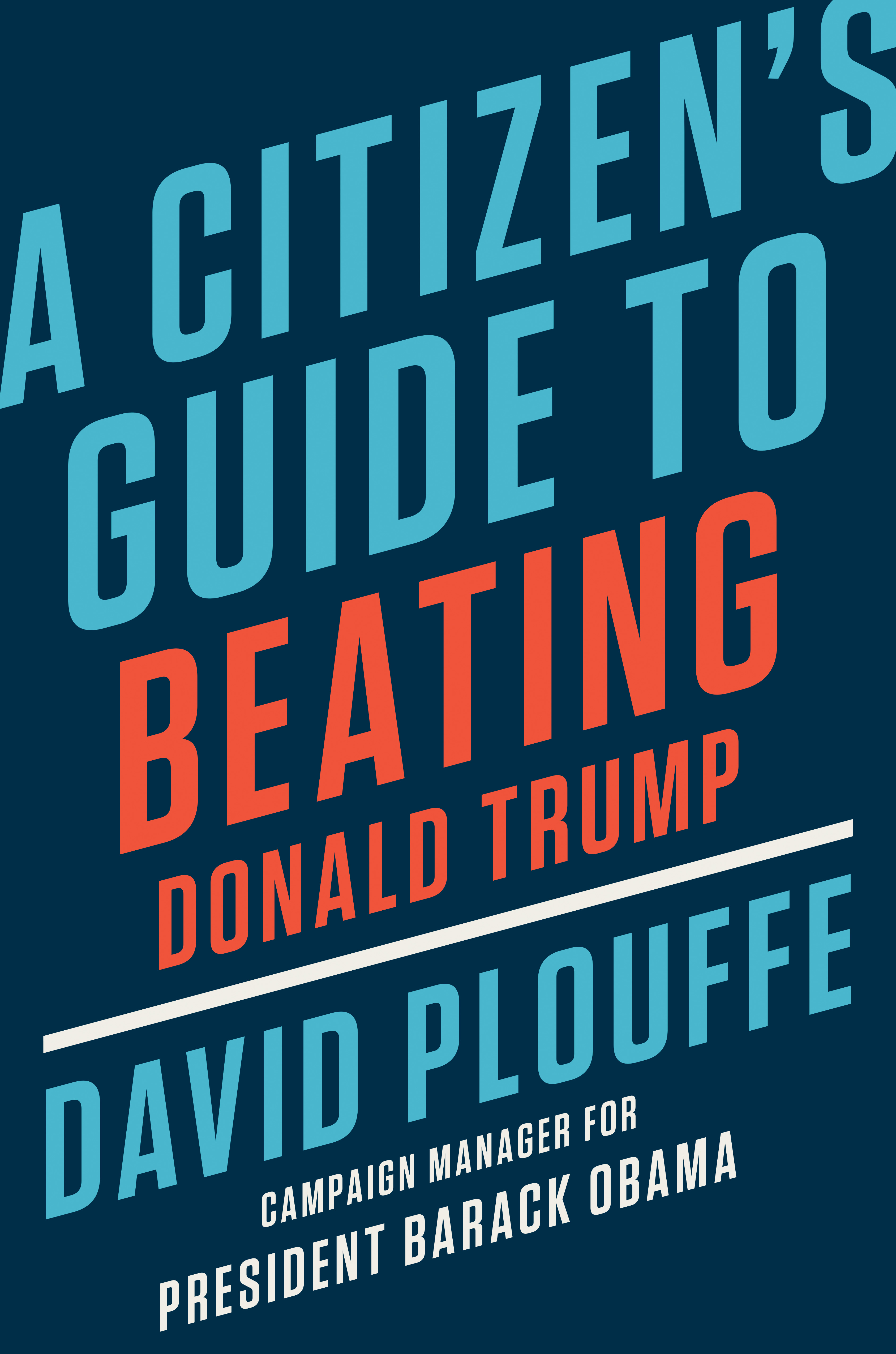
A Citizen's Guide to Beating Donald Trump A NEW YORK TIMES BESTSELLER As seen on CBS This Morning, PBS NewsHour, The Daily Show with Trevor Noah, Pod Save America and more A voter's playbook on making a difference in the 2020 election and beyond from the most recognized and most successful political strategist in the country If you've asked yourself the question, what more can I do to make sure Donald Trump does not continue to occupy the Oval Office on January 20, 2021?--then this book is for you. A playbook for the common citizen, A Citizen's Guide to Beating Donald Trump addresses the many things individuals can do in 2020 every day, without having to leave their jobs, move to Iowa, or spend every waking moment on the election. In A Citizen's Guide to Beating Donald Trump, Plouffe's message is simple: the only way change happens, especially on scale, is one human being talking to another. It won't happen magically, it won't happen because of debates and conventions, it won't happen because of ads. It will happen because citizens take action. And Plouffe is here to help, with specific strategies and tailored talking points to make sure your time and energy aren't wasted. He lays out why different activities the average citizen can take can make a difference to getting to 270 electoral votes, how people can go about doing them and examples of where it's worked in the past. There are at least 65 million Americans who are likely committed to voting against Trump. It is entirely in our control to grow that number and make sure the support materializes in actual votes. Plouffe arms us with advice on how to defend against misinformation online, how to create and spread content, how to register and get out the vote early, how to make a difference in the battlegrounds and how to stay involved after the big election. Filled with stories from the last sixteen years, both successes and failures, as well as political strategies that have evolved in the wake of the breakthrough campaign that Plouffe masterminded, A Citizen's Guide to Beating Donald Trump is a pragmatic, specific, and very motivational guide for the path forward. POLITICAL SCIENCE,Civics & Citizenship
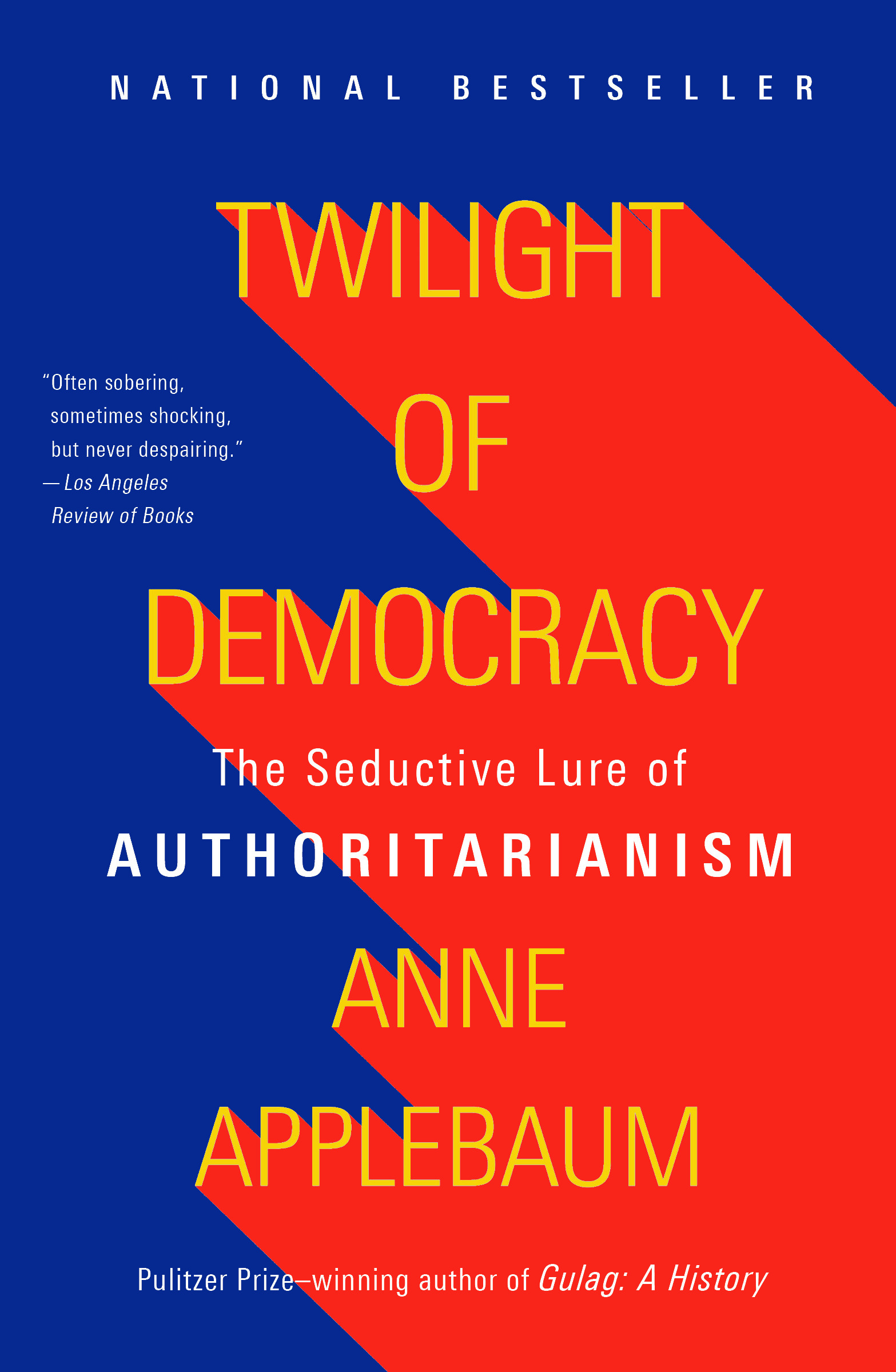
Twilight of Democracy "How did our democracy go wrong? This extraordinary document . . . is Applebaum's answer." —Timothy Snyder, author of On Tyranny A Pulitzer Prize–winning historian explains, with electrifying clarity, why elites in democracies around the world are turning toward nationalism and authoritarianism. From the United States and Britain to continental Europe and beyond, liberal democracy is under siege, while authoritarianism is on the rise. In Twilight of Democracy, Anne Applebaum, an award-winning historian of Soviet atrocities who was one of the first American journalists to raise an alarm about antidemocratic trends in the West, explains the lure of nationalism and autocracy. In this captivating essay, she contends that political systems with radically simple beliefs are inherently appealing, especially when they benefit the loyal to the exclusion of everyone else. Despotic leaders do not rule alone; they rely on political allies, bureaucrats, and media figures to pave their way and support their rule. The authoritarian and nationalist parties that have arisen within modern democracies offer new paths to wealth or power for their adherents. Applebaum describes many of the new advocates of illiberalism in countries around the world, showing how they use conspiracy theory, political polarization, social media, and even nostalgia to change their societies. Elegantly written and urgently argued, Twilight of Democracy is a brilliant dissection of a world-shaking shift and a stirring glimpse of the road back to democratic values. POLITICAL SCIENCE,Civics & Citizenship
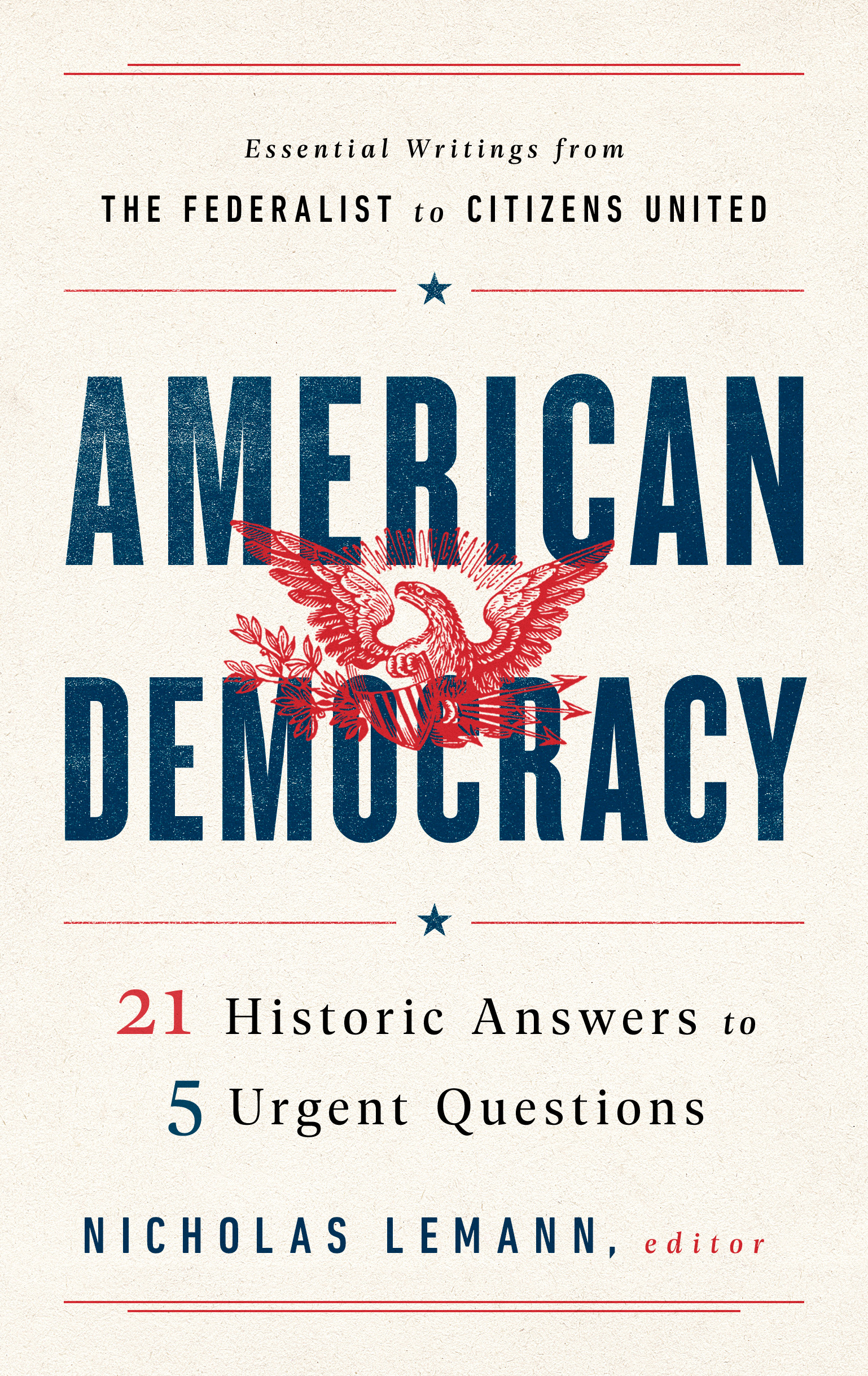
American Democracy From The Federalist to Citizens United, bestselling author Nicholas Lemann presents key writings on five crucial questions confronting American democracy today Amid the frenzied overload of 24-hour cable news and incessant social media, at a time when many of us fear for the future of our democracy, it is becoming harder and harder to think clearly about politics. American Democracy: 21 Historic Answers to 5 Urgent Questions provides an alternative for those who want to step back and look to the past for inspiration and guidance. Edited with perceptive and provocative commentary by bestselling historian and journalist Nicholas Lemann (The Promised Land, Transaction Man), the book presents key writings from the American past that speak to five contemporary flashpoints in our political landscape: race, gender, immigration, and citizenship; opportunity and inequality; the purpose and powers of the federal government; money, special privilege, and corruption; and protest and civil disobedience. Some of the selections are well-known--George Washington's letter to the Hebrew Congregation at Newport, Frederick Douglass's "What to the Slave is the 4th of July," Martin Luther King Jr.'s letter from Birmingham Jail--while others will be new to many readers--Horace Mann argument for public schools as a means of fighting inequality, Jane Addams's perceptive analysis of gender and social class in charity work, Randolph Bourne envisioning a "Trans-National America." American Democracy presents a remarkable range of insightful and eloquent American political writing, while serving as an invaluable resource for concerned citizens who wish to become better-informed participants in the ongoing drama of our democracy. POLITICAL SCIENCE,Civics & Citizenship

In the Hands of the People Pulitzer Prize–winning historian Jon Meacham offers a collection of inspiring words about how to be a good citizen, from Thomas Jefferson and others, and reminds us why our country’s founding principles are still so important today. Thomas Jefferson believed in the covenant between a government and its citizens, in both the government’s responsibilities to its people and also the people’s responsibility to the republic. In this illuminating book, a project of the Thomas Jefferson Foundation at Monticello, the #1 New York Times bestselling author Jon Meacham presents selections from Jefferson’s writing on the subject, with an afterword by Pulitzer Prize–winning historian Annette Gordon-Reed and comments on Jefferson’s ideas from others, including Colin Powell, Madeleine Albright, Frederick Douglass, Carl Sagan, and American presidents. This curated collection revitalizes how to see an individual’s role in the world, as it explores such Jeffersonian concepts as religious freedom, the importance of a free press, public education, participation in government, and others. Meacham writes, “In an hour of twenty-first-century division and partisanship, of declining trust in institutions and of widespread skepticism about the long-term viability of the American experiment, it is instructive to return to first principles. Not, to be sure, as an exercise in nostalgia or as a flight from the reality of our own time, but as an honest effort to see, as Jefferson wrote, what history may be able to tell us about the present and the future.” POLITICAL SCIENCE,Civics & Citizenship

Presidential Playbook 2020 “And sometime, at some point, do something for your country.”That quote from Pulitzer Prize-winning historian David McCullough resonated so deeply with Trek Bicycle President John Burke that he set out to write a book laying out his vision for the country, an America that can once again be a shining city on a hill. Burke says it's time to cut through the political fog and deal with the facts: The U.S. is facing serious, long-term problems, and politicians in Washington, D.C. are ignoring them. These critical issues can be resolved, he says, with the determination and shared sacrifice of the American people.From battling climate change to saving Social Security, from reducing the risk of nuclear war to rebuilding crumbling roads and bridges, from campaign finance reform to improving the health of Americans, John Burke offers his 16 Simple Solutions for putting the United States on a stronger foundation.This is his Presidential Playbook, a plan for America's future – and a call for all Americans to come together and ... do something for our country. POLITICAL SCIENCE,Civics & Citizenship
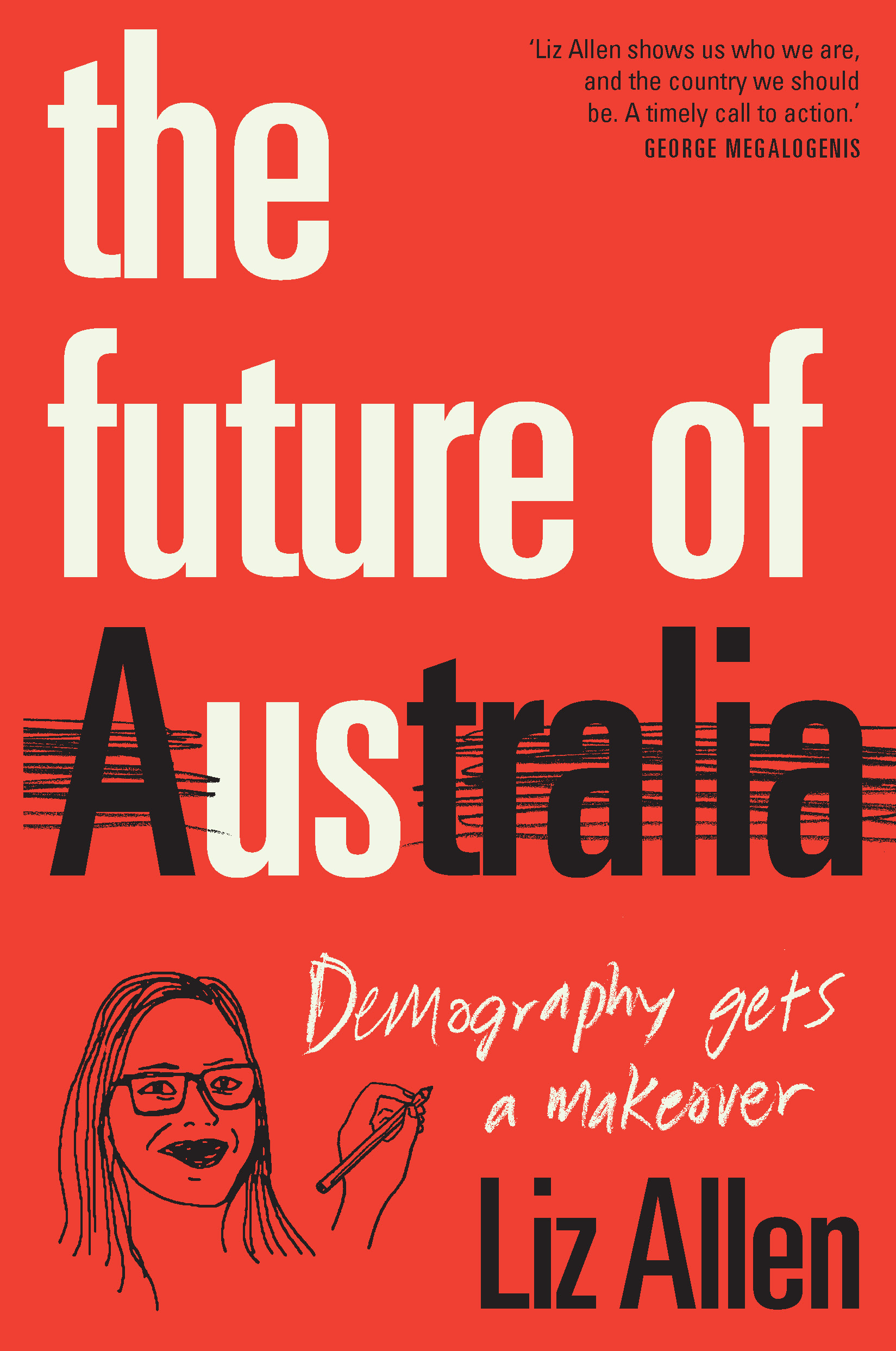
The Future of Us Demography is far more important than destiny. By tracing connections between a population's past and present, demographers can foresee its future. The true wonder of demography, though, is not its ability to predict the future but to shape it. With energy and passion, demographer Liz Allen sets out the potential paths to make Australia better. Bold, fearless, and revealing, The Future of Usdoes more than help you find your inner statistician. Looking beyond births, deaths, and marriages, Allen takes apart inequality, migration, tax, and home ownership. She also dissects how the word 'population' became so charged, daring to ask what Australia might look like in 20 years if we had zero immigration. The Future of Us gives demography a makeover and sets out future possibilities for a better us…just like a Choose Your Own Adventure, but for the nation. POLITICAL SCIENCE,Civics & Citizenship

Sanctuary Regions and the Struggle for Belonging This book argues that local governments and institutions across the state of California that offer various forms of sanctuaries to undocumented immigrants create “sanctuary regions.†These regions are safe zones for undocumented immigrants and facilitate their ability to make claims for human rights. The book also argues that these regions create an important form of resistance to federal state authority in terms of immigration and the management of borders – something that is typically attributed to state power in the study of International Relations (IR). This book includes overviews of how undocumented immigrants make claims for human rights as well as the ways in which sanctuary regions facilitate “acts of citizenship†and resist anti-immigrant policies. POLITICAL SCIENCE,Civics & Citizenship
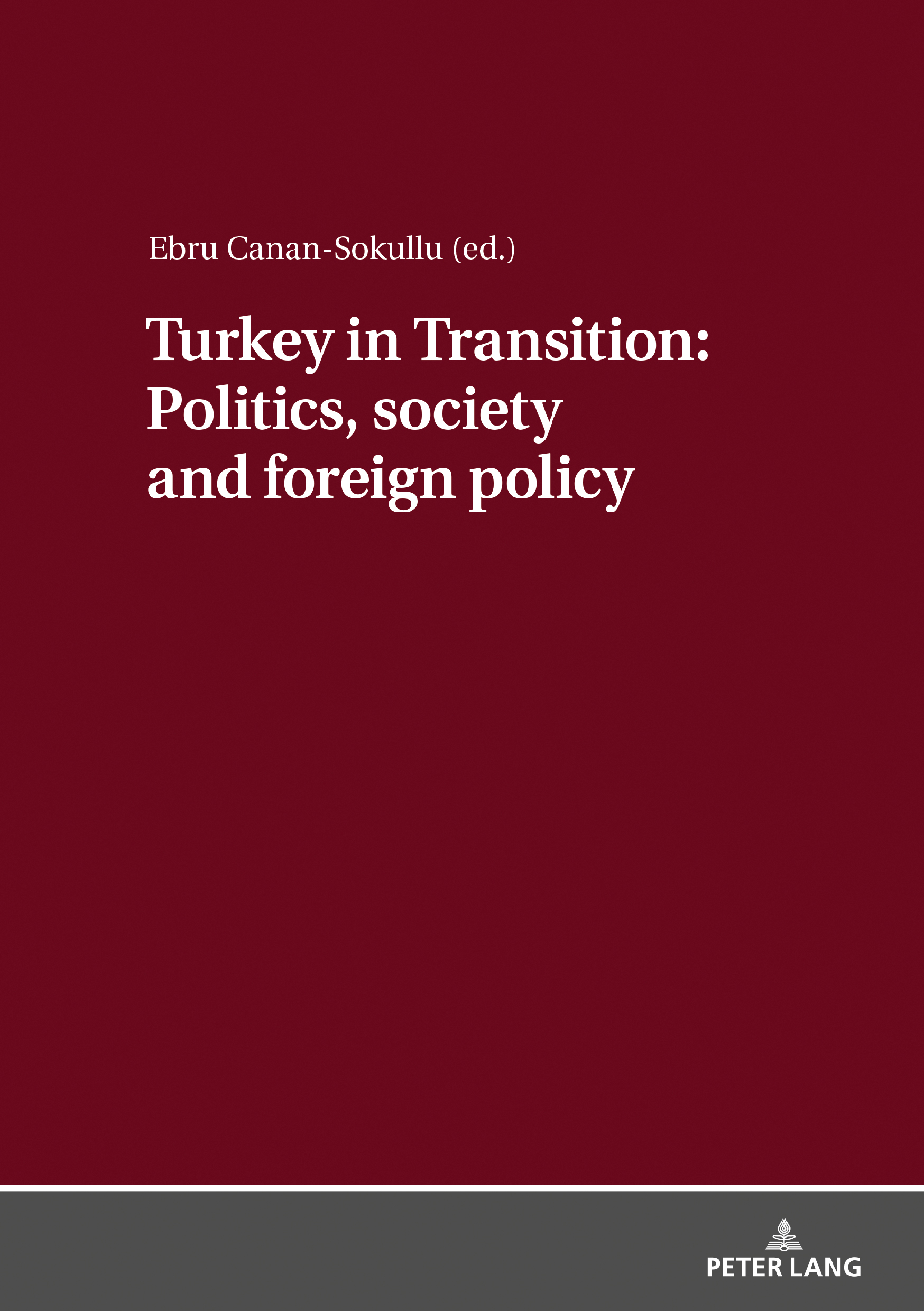
Turkey in Transition This book expands upon transitions in political and societal fabric of Turkey together with its eventual reorientation of foreign policy in broader regional and global contexts during the Justice and Freedom Party era. POLITICAL SCIENCE,Civics & Citizenship
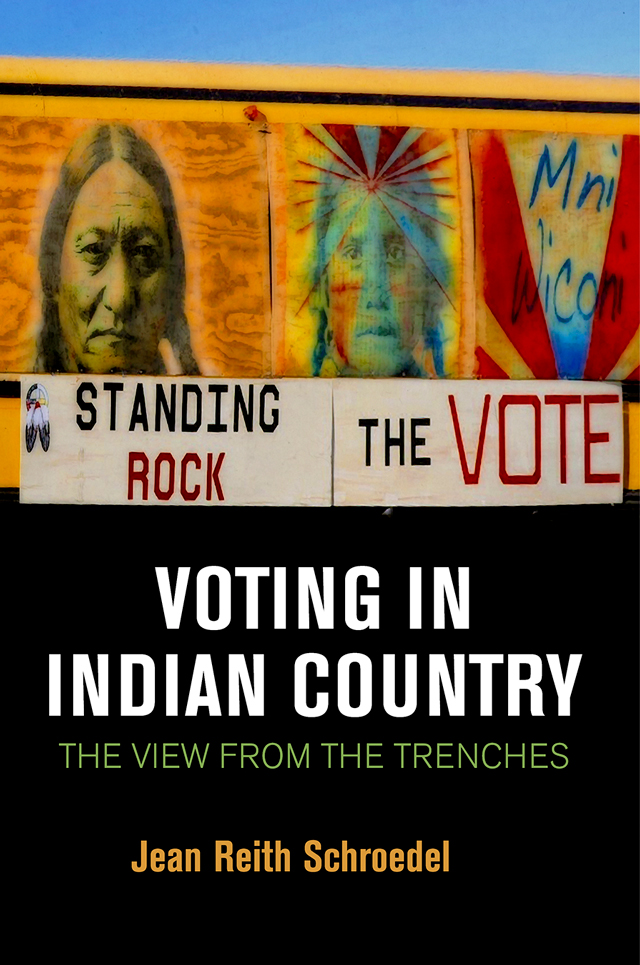
Voting in Indian Country Voting in Indian Country uses conflicts over voting rights to understand the centuries-long fight for Native self-determination, using ethnographic data and weaving together history, politics, and law to provide a robust view of this often-ignored struggle for social justice. POLITICAL SCIENCE,Civics & Citizenship

Bosnian Post-Refugee Transnationalism This book develops a new concept of post-refugee transnationalism to describe experiences of Bosnian refugees who settled in Ireland after fleeing the conflict in 1990s Bosnia and Herzegovina. The book explores their ambivalent relationship with their host and home countries, Ireland and Bosnia, arguing that their current experiences are best described as post-refugee transnationalism. Post-refugee transnationalism is characterised by Bosnians dividing their time between the two countries rather than permanently settling in either and by engaging in summer migrations and diasporic interconnections and affiliations. The book proposes post-refugee transnationalism as different to other instances of transnationalism by stressing its enforced origin provoked by the conflict and institutionalized by the Dayton Peace Agreement. The book combines Foucault’s biopolitics, David Theo Goldberg’s understanding of nation states as racial states and Giorgio Agamben’s expansion on the idea of potentiality, to develop the concept of post-refugee transnationalism. POLITICAL SCIENCE,Civics & Citizenship

Our Malady NEW YORK TIMES BESTSELLER • From the author of the #1 New York Times bestseller On Tyranny comes an impassioned condemnation of America's coronavirus response and an urgent call to rethink health and freedom. On December 29, 2019, historian Timothy Snyder fell gravely ill. Unable to stand, barely able to think, he waited for hours in an emergency room before being correctly diagnosed and rushed into surgery. Over the next few days, as he clung to life and the first light of a new year came through his window, he found himself reflecting on the fragility of health, not recognized in America as a human right but without which all rights and freedoms have no meaning. And that was before the pandemic. We have since watched American hospitals, long understaffed and undersupplied, buckling under waves of coronavirus patients. The federal government made matters worse through willful ignorance, misinformation, and profiteering. Our system of commercial medicine failed the ultimate test, and thousands of Americans died. In this eye-opening cri de coeur, Snyder traces the societal forces that led us here and outlines the lessons we must learn to survive. In examining some of the darkest moments of recent history and of his own life, Snyder finds glimmers of hope and principles that could lead us out of our current malaise. Only by enshrining healthcare as a human right, elevating the authority of doctors and medical knowledge, and planning for our children’s future can we create an America where everyone is truly free. POLITICAL SCIENCE,Civics & Citizenship

Wait! Don't Move to Canada Popular political pundit Bill Scher--whom the Hartford Advocate has called "one of the sharpest political minds around"--presents a bold, pragmatic plan to revitalize America Frustrated liberals are mired in the political wilderness, while disgruntled Democrats and Republicans have grown weary of unprincipled politics, shoddy governance, and the general ineptitude of our public servants. "Look, it would be a lot easier to cut and run to Canada," say Janeane and Sam in their foreword, "but we all have an obligation not to." To those willing to stay and fight, Bill Scher offers a 10-step plan to rally popular support for a better, more effective, more liberal vision of government. To achieve this vision, Scher arms his readers with an arsenal of attitude and practical, actionable advice on how to: • defuse the right-wing culture war• communicate directly with the news media and encourage them to cover underreported stories• protest in a way that reaches those outside the ranks of activist organizations• join the growing online liberal community to effectively exert pressure on the political establishment• embrace the term liberal as often and as openly as possible Scher, whose Web log LiberalOasis.com is one of the go-to political sites in the rapidly expanding--and increasingly influential--blogosphere, articulates his strategies in a straightforward, vibrant, and accessible style that explodes the stereotypes of the liberal wimp or egghead. POLITICAL SCIENCE,Civics & Citizenship
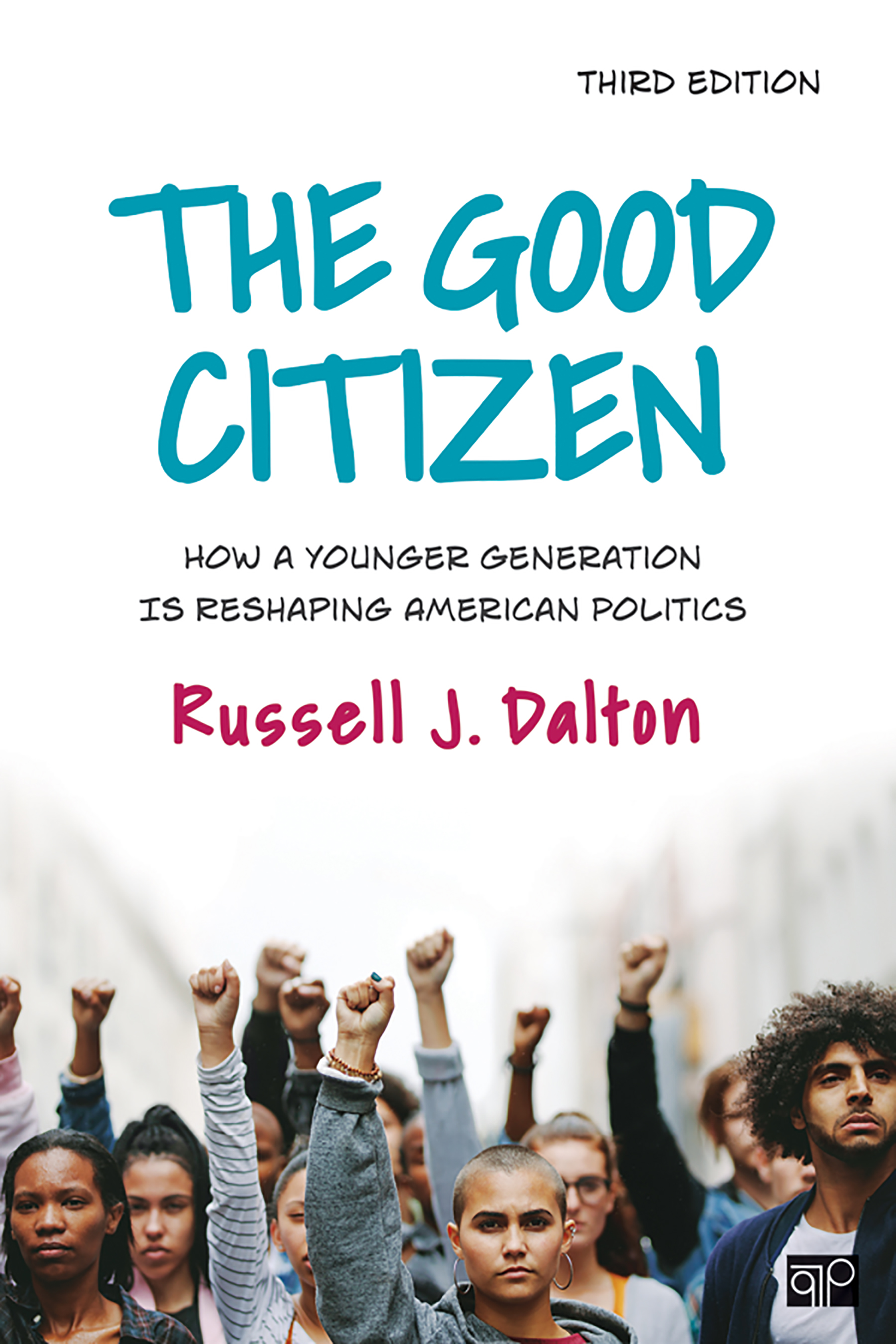
The Good Citizen In this third edition of The Good Citizen, Russell Dalton uses current national public opinion surveys, including new evidence from 2018 Pew Center survey data, to show how Americans are changing their views on what good citizenship means. It’s not about recreating the halcyon politics of a generation ago, but recognition that new patterns of citizenship call for new processes and new institutions that reflect the values of the contemporary American public. Trends in participation, tolerance, and policy priorities reflect a younger generation that is more engaged, more tolerant, and more supportive of social justice. The Good Citizen shows how a younger generation is creating new norms of citizenship that are leading to a renaissance of democratic participation. An important comparative chapter in the book showcases cross-national comparisons that further demonstrate the vitality of American democracy. POLITICAL SCIENCE,Civics & Citizenship

Citizenship The story of citizenship as a tale not of liberation, dignity, and nationhood but of complacency, hypocrisy, and domination. The glorification of citizenship is a given in today's world, part of a civic narrative that invokes liberation, dignity, and nationhood. In reality, explains Dimitry Kochenov, citizenship is a story of complacency, hypocrisy, and domination, flattering to citizens and demeaning for noncitizens. In this volume in the MIT Press Essential Knowledge series, Kochenov explains the state of citizenship in the modern world. Kochenov offers a critical introduction to a subject most often regarded uncritically, describing what citizenship is, what it entails, how it came about, and how its role in the world has been changing. He examines four key elements of the concept: status, considering how and why the status of citizenship is extended, what function it serves, and who is left behind; rights, particularly the right to live and work in a state; duties, and what it means to be a “good citizen”; and politics, as enacted in the granting and enjoyment of citizenship. Citizenship promises to apply the attractive ideas of dignity, equality, and human worth—but to strictly separated groups of individuals. Those outside the separation aren't citizens as currently understood, and they do not belong. Citizenship, Kochenov warns, is too often a legal tool that justifies violence, humiliation, and exclusion. POLITICAL SCIENCE,Civics & Citizenship

Constitution Café “A provocative extension of Jefferson’s original plan.â€â€”Kirkus Reviews Thomas Jefferson believed that every generation of Americans should rewrite our Constitution from scratch—to mirror the progress of the human mind and, most of all, to maintain the revolutionary spirit. He would be dismayed that it’s considered untouchable these days. Taking up Jefferson’s cause, Christopher Phillips leads a motley group of Americans across the fruited plain in an offbeat Constitutional Convention. His Constitution Café project is sparking a much-needed conversation about our founding document and forging common ground at a time when our country needs it most. POLITICAL SCIENCE,Civics & Citizenship
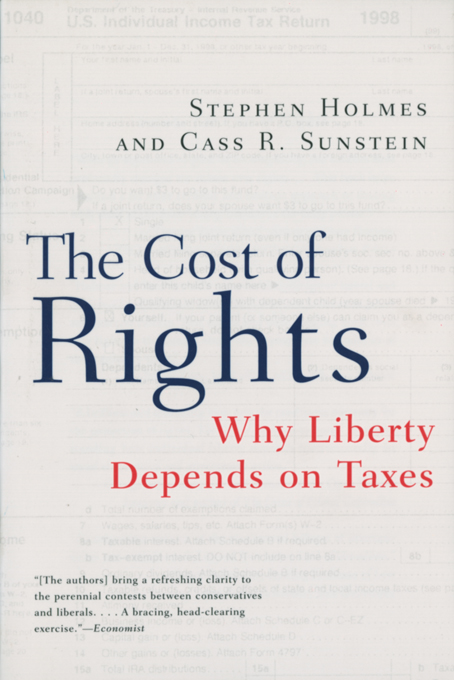
The Cost of Rights To "fight for your rights," or anyone else's, is not just to debate principles but to haggle over budgets. The simple insight that all legally enforceable rights cost money reminds us that freedom is not violated by a government that taxes and spends, but requires it—and requires a citizenry vigilant about how money is allocated. Drawing from these practical, commonsense notions, The Cost of Rights provides a useful corrective to the all-or-nothing feel of much political debate nowadays (The Economist). POLITICAL SCIENCE,Civics & Citizenship

A Call to Conscience A powerful collection of the most essential speeches from famed social activist and key civil rights figure Dr. Martin Luther King, Jr. This companion volume to A Knock At Midnight: Inspiration from the Great Sermons of Rev. Martin Luther King, Jr. includes the text of his most well-known oration, "I Have a Dream", his acceptance speech for the Nobel Peace Prize, and Beyond Vietnam, a powerful plea to end the ongoing conflict. Includes contributions from Rosa Parks, Aretha Franklin, the Dalai Lama, and many others. POLITICAL SCIENCE,Civil Rights
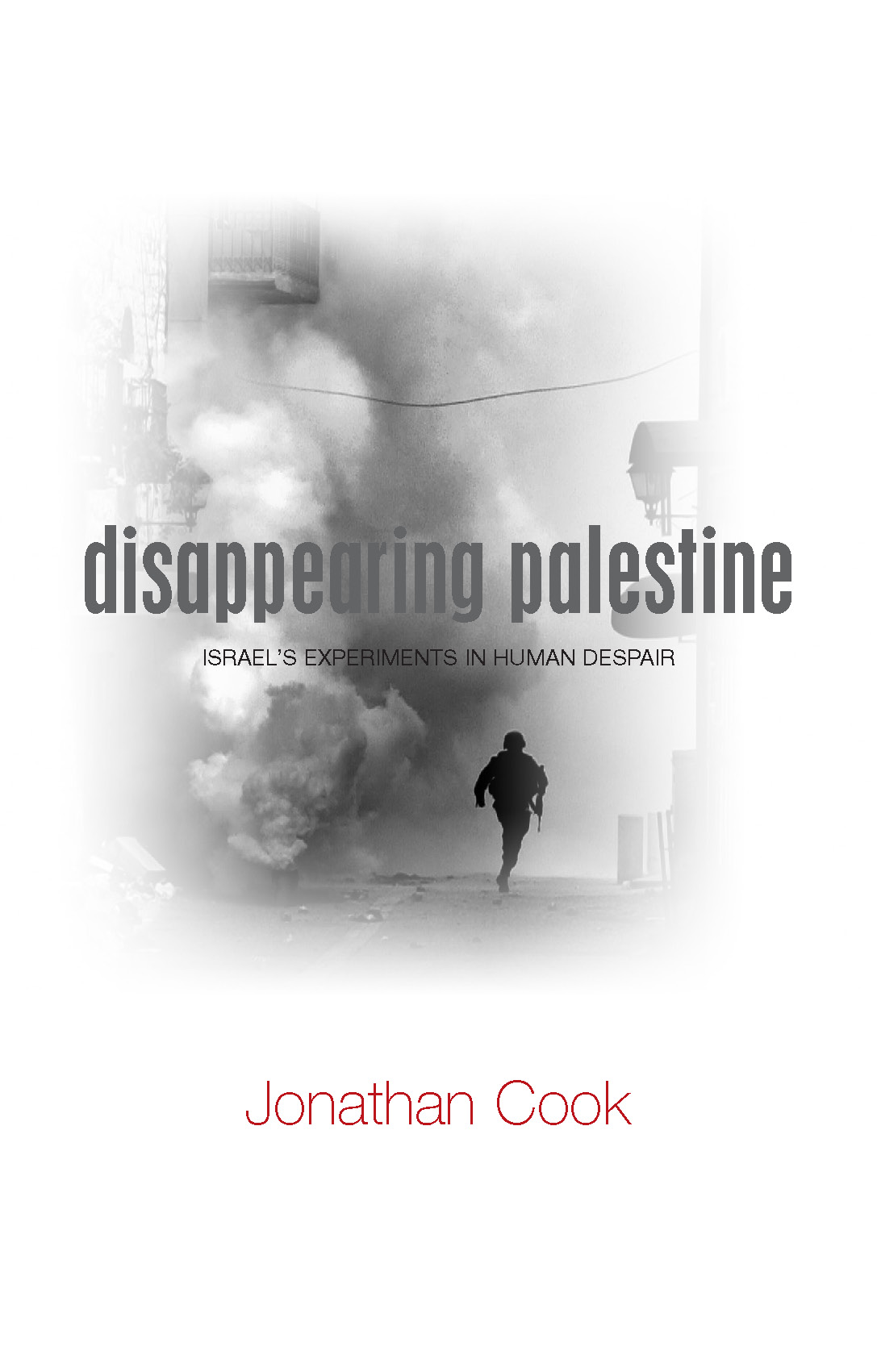
Disappearing Palestine Palestine is disappearing - fulfilling the objectives of Israel's founding fathers. This book exposes the dismal failure of the Israeli left, human rights organisations and the global media to hold Israel to account. It is a controversial analysis of one of the conflicts in contemporary world politics. POLITICAL SCIENCE,Civil Rights

Still a House Divided Why race remains the central political issue in America today Why have American policies failed to reduce the racial inequalities still pervasive throughout the nation? Has President Barack Obama defined new political approaches to race that might spur unity and progress? Still a House Divided examines the enduring divisions of American racial politics and how these conflicts have been shaped by distinct political alliances and their competing race policies. Combining deep historical knowledge with a detailed exploration of such issues as housing, employment, criminal justice, multiracial census categories, immigration, voting in majority-minority districts, and school vouchers, Desmond King and Rogers Smith assess the significance of President Obama's election to the White House and the prospects for achieving constructive racial policies for America's future. Offering a fresh perspective on the networks of governing institutions, political groups, and political actors that influence the structure of American racial politics, King and Smith identify three distinct periods of opposing racial policy coalitions in American history. The authors investigate how today's alliances pit color-blind and race-conscious approaches against one another, contributing to political polarization and distorted policymaking. Contending that President Obama has so far inadequately confronted partisan divisions over race, the authors call for all sides to recognize the need for a balance of policy measures if America is to ever cease being a nation divided. Presenting a powerful account of American political alliances and their contending racial agendas, Still a House Divided sheds light on a policy path vital to the country's future. POLITICAL SCIENCE,Civil Rights
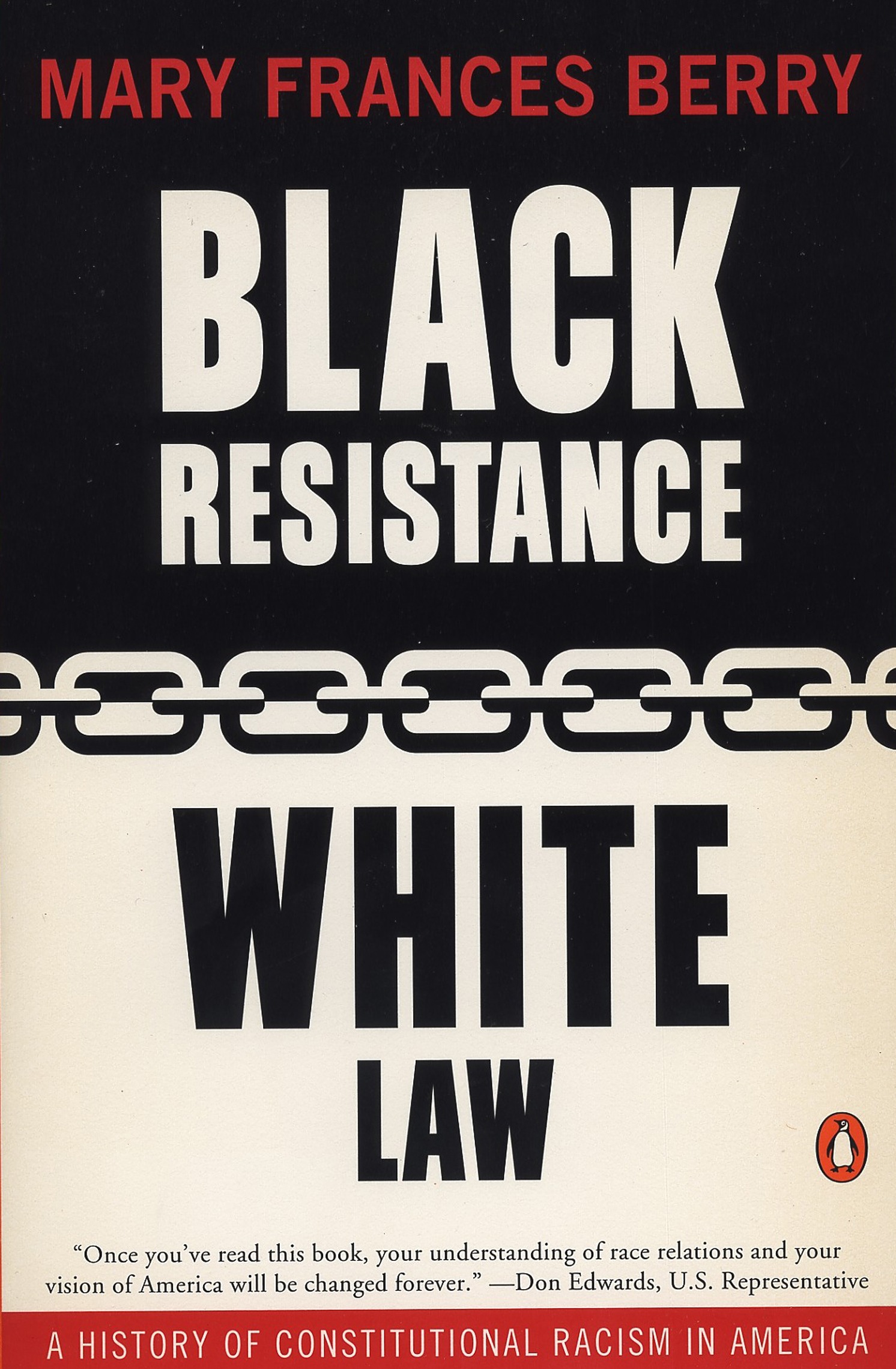
Black Resistance/White Law How the government has used the Constitution to deny black Americans their legal rights From the arrival of the first twenty slaves in Jamestown to the Howard Beach Incident of 1986, Yusef Hawkins, and Rodney King, federal law enforcement has pleaded lack of authority against white violence while endorsing surveillance of black rebels and using “constitutional” military force against them. In this groundbreaking study, constitutional scholar Mary Frances Berry analyzes the reasons why millions of African Americans whose lives have improved enormously, both socially and economically, are still at risk of police abuse and largely unprotected from bias crimes. POLITICAL SCIENCE,Civil Rights

Across That Bridge Winner of the NAACP Image Award for Outstanding Literary Work/Biography. In Across That Bridge, Congressman John Lewis draws from his experience as a prominent leader of the Civil Rights Movement to offer timeless wisdom, poignant recollections, and powerful principles for anyone interested in challenging injustices and inspiring real change toward a freer, more peaceful society. The Civil Rights Movement gave rise to the protest culture we know today, and the experiences of leaders like Congressman Lewis, a close confidant to Martin Luther King, Jr., have never been more relevant. Despite more than forty arrests, physical attacks, and serious injuries, John Lewis has remained a devoted advocate of the discipline and philosophy of nonviolence. Now, in an era in which the protest culture he helped forge has resurfaced as a force for change, Lewis' insights have never been more relevant. In this heartfelt book, Lewis explores the contributions that each generation must make to achieve change. POLITICAL SCIENCE,Civil Rights
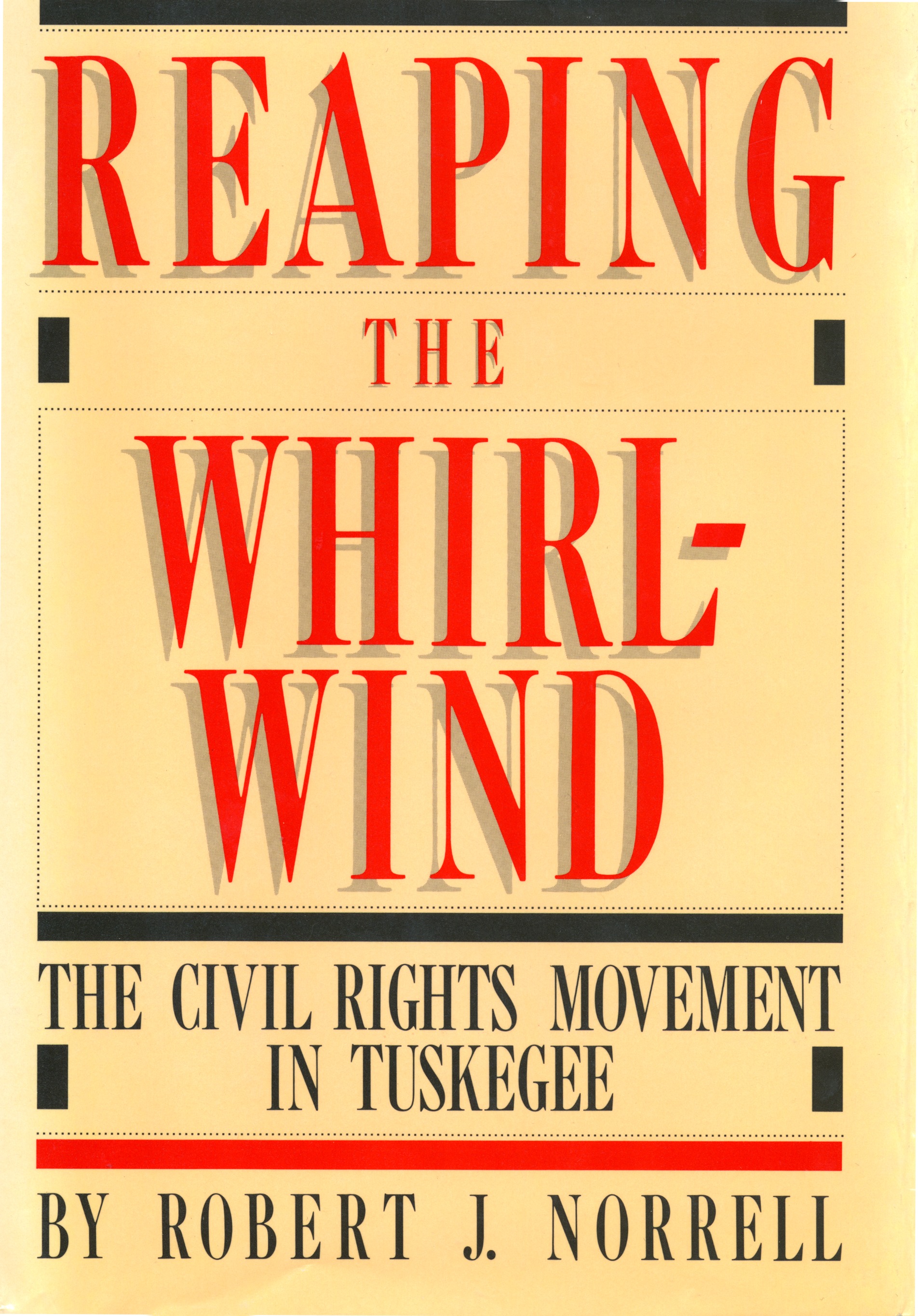
Reaping the Whirlwind Bringing us close to the complex history of the civil rights movement in the American South—the currents that involved thousands of communities and millions of individual lives—this book looks deeply into the experiences of a single Alabama town, Tuskegee, and its surrounding Macon County. It is based on interviews with the people—white and black, liberal and traditional—whose lives were caught up in the movement and altered forever. We see Tuskegee in the early 1940s, seat of America’s most venerable institute of high education for blacks, an important symbol of black progress—yet almost entirely controlled by a white power structure—and we see the emergence of a charismatic leader, Charles G. Gomillion, who defied Tuskegee Institutes’ apolitical traditions and inspired blacks to organize for their right to vote. Thus begins decades of struggle, which Robert J. Norrell re-creates for us through the testimony of the people who lived and shaped this history: the dramatic appearance before a U.S. congressional committee of local civil rights leaders and ordinary farmers bearing witness to the seemingly endless obstructions to block voter registration; the months-long boycott of white Tuskegee merchants that was sparked by the city council’s attempt to exclude black voters by gerrymandering; the fiercely controversial move to integrate the public schools that culminated in Governor George Wallace’s order to state troopers to prevent the opening of Tuskegee High; the anguish that accompanied efforts by blacks to penetrate all-white church congregations. Norrell describes how blacks enters—and won—local elections, including those for mayor and sheriff, and how, with the onset of heightened activism in the late 1960s, Gomillion and other established leaders of the civil rights movement heard angry youthful voices raised against their cautious approach. Reaping the Whirlwind carries us through the early 1970s to a community profoundly changed, proud to have shed its false air of harmony, gradually coming to terms with the disorder and dissension of the preceding years. It is a moving and significant chronicle that documents a critical era in the nation’s history. POLITICAL SCIENCE,Civil Rights
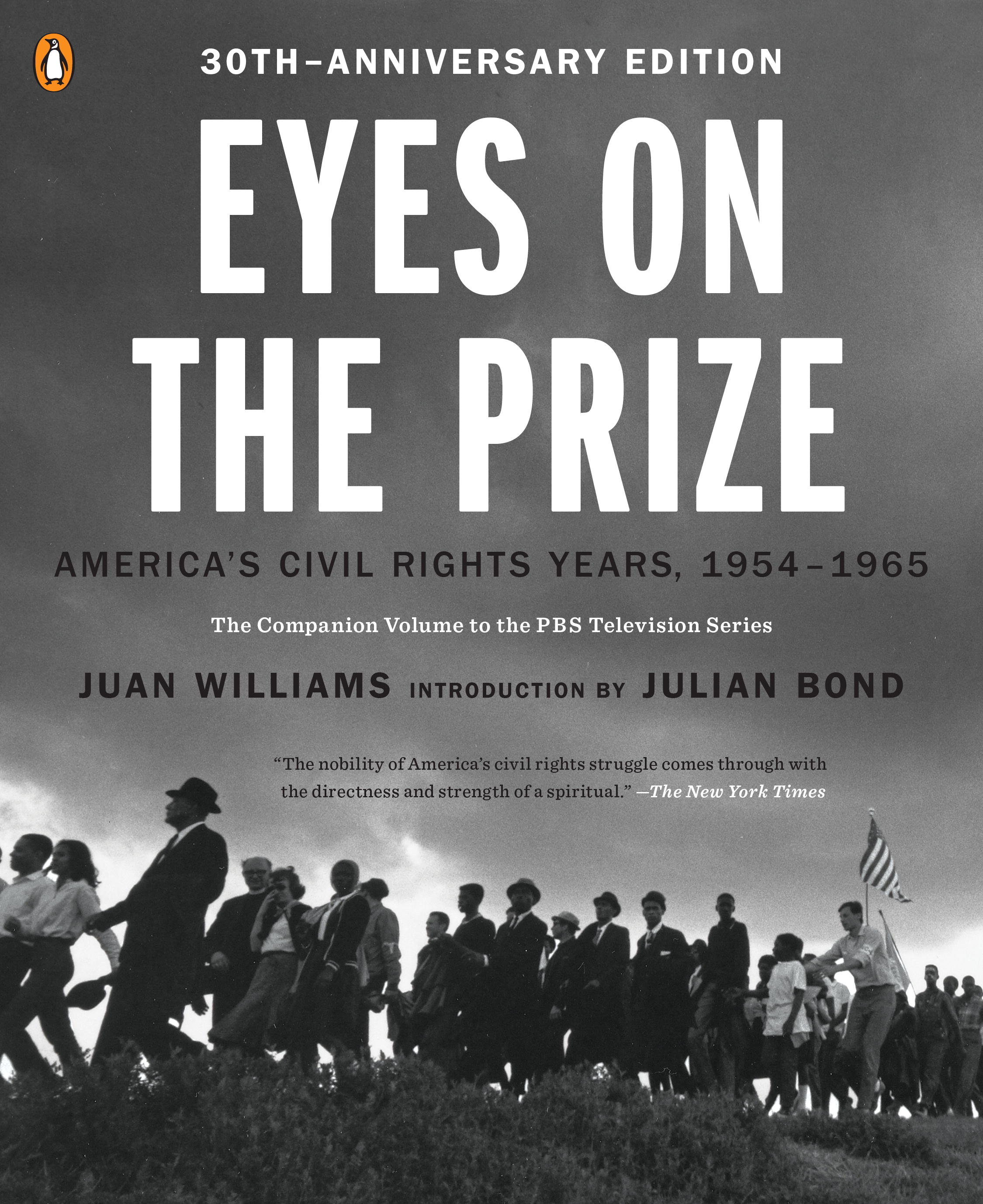
Eyes on the Prize Eyes on the Prize traces the movement from the landmark Brown v. the Board of Education case in 1954 to the march on Selma and the passage of the Voting Rights Act in 1965. This is a companion volume to the first part of the acclaimed PBS series. POLITICAL SCIENCE,Civil Rights

The Fire Next Time An official Oprah Winfrey’s “The Books That Help Me Through” selection A national bestseller when it first appeared in 1963, The Fire Next Time galvanized the nation, gave passionate voice to the emerging civil rights movement—and still lights the way to understanding race in America today. "Basically the finest essay I’ve ever read. . . . Baldwin refused to hold anyone’s hand. He was both direct and beautiful all at once. He did not seem to write to convince you. He wrote beyond you.” --Ta-Nehisi Coates At once a powerful evocation of James Baldwin's early life in Harlem and a disturbing examination of the consequences of racial injustice, the book is an intensely personal and provocative document from the iconic author of If Beale Street Could Talk and Go Tell It on the Mountain. It consists of two "letters," written on the occasion of the centennial of the Emancipation Proclamation, that exhort Americans, both black and white, to attack the terrible legacy of racism. Described by The New York Times Book Review as "sermon, ultimatum, confession, deposition, testament, and chronicle...all presented in searing, brilliant prose," The Fire Next Time stands as a classic of literature. POLITICAL SCIENCE,Civil Rights

Unwarranted “At a time when policing in America is at a crossroads, Barry Friedman provides much-needed insight, analysis, and direction in his thoughtful new book. Unwarranted illuminates many of the often ignored issues surrounding how we police in America and highlights why reform is so urgently needed. This revealing book comes at a critically important time and has much to offer all who care about fair treatment and public safety.†—Bryan Stevenson, founder and Executive Director of the Equal Justice Initiative and author of Just Mercy: A Story of Justice and Redemption In June 2013, documents leaked by Edward Snowden sparked widespread debate about secret government surveillance of Americans. Just over a year later, the shooting of Michael Brown, a black teenager in Ferguson, Missouri, set off protests and triggered concern about militarization of law enforcement and discriminatory policing. In Unwarranted, Barry Friedman argues that these two seemingly disparate events are connected—and that the problem is not so much the policing agencies as it is the rest of us. We allow these agencies to operate in secret and to decide how to police us, rather than calling the shots ourselves. And the courts, which we depended upon to supervise policing, have let us down entirely. Unwarranted tells the stories of ordinary people whose lives were torn apart by policing—by the methods of cops on the beat and those of the FBI and NSA. Driven by technology, policing has changed dramatically. Once, cops sought out bad guys; today, increasingly militarized forces conduct wide surveillance of all of us. Friedman captures the eerie new environment in which CCTV, location tracking, and predictive policing have made suspects of us all, while proliferating SWAT teams and increased use of force have put everyone’s property and lives at risk. Policing falls particularly heavily on minority communities and the poor, but as Unwarranted makes clear, the effects of policing are much broader still. Policing is everyone’s problem. Police play an indispensable role in our society. But our failure to supervise them has left us all in peril. Unwarranted is a critical, timely intervention into debates about policing, a call to take responsibility for governing those who govern us. POLITICAL SCIENCE,Civil Rights
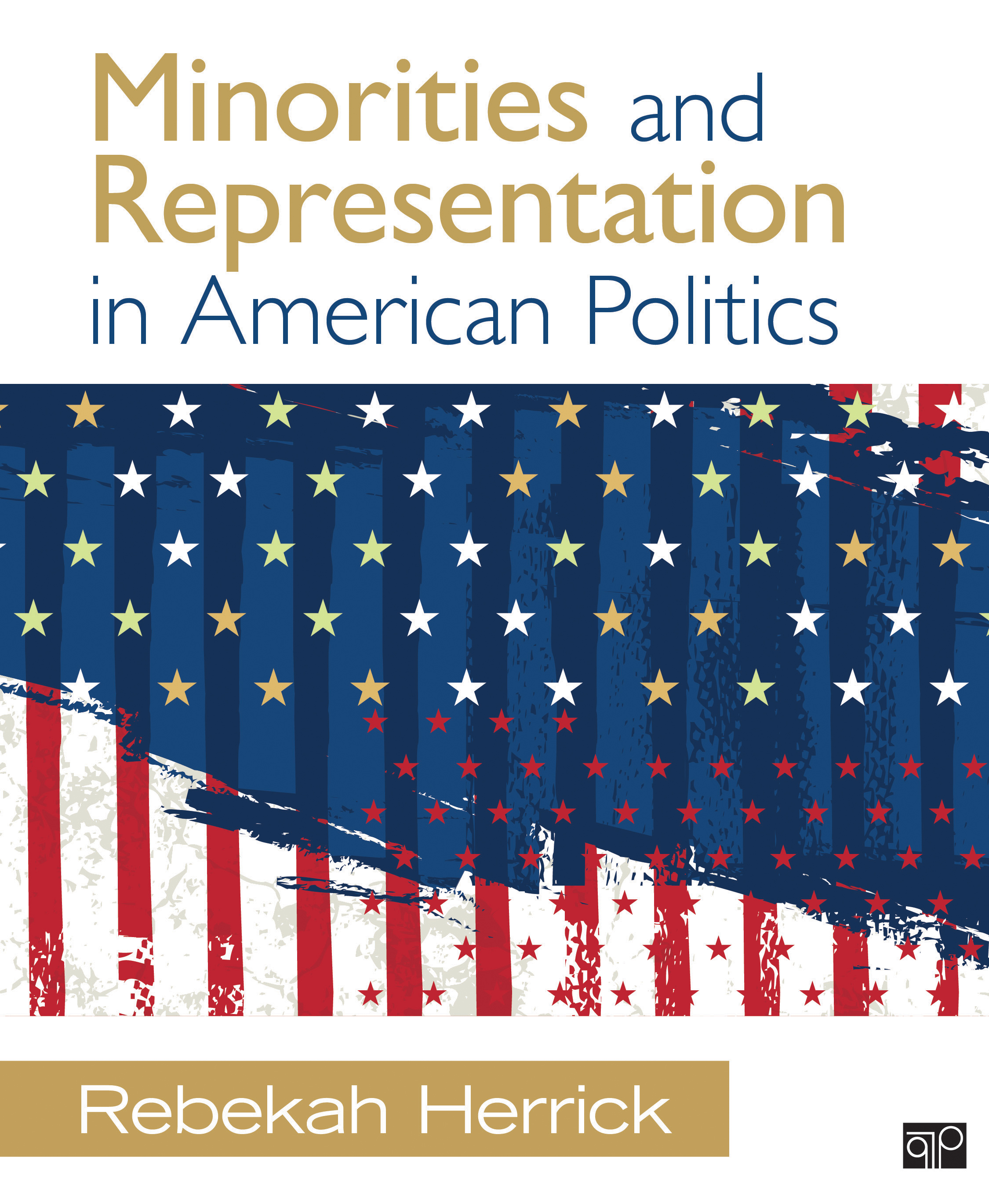
Minorities and Representation in American Politics Minorities and Representation in American Politics is the first book of its kind to examine underrepresented minorities with a framework based on four types of representation—descriptive, formalistic, symbolic, and substantive. Through this lens, author Rebekah Herrick looks at race, ethnic, gender, and sexual minorities not in isolation but synthesized within every chapter. This enables readers to better recognize both the similarities and differences of groups’ underrepresentation. Herrick also applies her unique and constructive approach to intergroup cooperation and intersectionality, highlighting the impact that groups can have on one another. POLITICAL SCIENCE,Civil Rights

Surviving Justice Innocent, but imprisoned—troubling stories of wrongful conviction Surviving Justice presents oral histories of thirteen people from all walks of life, who, through a combination of all-too-common factors— overzealous prosecutors, inept defense lawyers, coercive interrogation tactics, eyewitness misidentification—found themselves imprisoned for crimes they did not commit. The stories these exonerated men and women tell are spellbinding, heartbreaking, and ultimately inspiring. Among the narrators: Paul Terry, who spent twenty-seven years wrongfully imprisoned, and emerged psychologically devastated and barely able to communicate. Beverly Monroe, an organic chemist who was coerced into falsely confessing to the murder of her lover. Freed after seven years, she faces the daunting task of rebuilding her life from the ground up. Joseph Amrine, who was sentenced to death for murder. Seventeen years later, when DNA evidence exonerated him, Amrine emerged from prison with nothing but the fourteen dollars in his inmate account. POLITICAL SCIENCE,Civil Rights

Beyond Trans Goes beyond transgender to question the need for gender classification Beyond Trans pushes the conversation on gender identity to its limits: questioning the need for gender categories in the first place. Whether on birth certificates or college admissions applications or on bathroom doors, why do we need to mark people and places with sex categories? Do they serve a real purpose or are these places and forms just mechanisms of exclusion? Heath Fogg Davis offers an impassioned call to rethink the usefulness of dividing the world into not just Male and Female categories but even additional categories of Transgender and gender fluid. Davis, himself a transgender man, explores the underlying gender-enforcing policies and customs in American life that have led to transgender bathroom bills, college admissions controversies, and more, arguing that it is necessary for our society to take real steps to challenge the assumption that gender matters. He examines four areas where we need to re-think our sex-classification systems: sex-marked identity documents such as birth certificates, driver’s licenses and passports; sex-segregated public restrooms; single-sex colleges; and sex-segregated sports. Speaking from his own experience and drawing upon major cases of sex discrimination in the news and in the courts, Davis presents a persuasive case for challenging how individuals are classified according to sex and offers concrete recommendations for alleviating sex identity discrimination and sex-based disadvantage. For anyone in search of pragmatic ways to make our world more inclusive, Davis’ recommendations provide much-needed practical guidance about how to work through this complex issue. A provocative call to action, Beyond Trans pushes us to think how we can work to make America truly inclusive of all people. POLITICAL SCIENCE,Civil Rights

Police Radical glossary of the vocabulary of policing that redefines the very way we understand law enforcement It doesn’t take firsthand experience to learn the meaning of pain compliance or rough ride. Police: A Field Guide is an illustrated handbook to the methods, mythologies, and history that animate today’s police. It is a survival manual for encounters with cops and police logic, whether it arrives in the shape of officer friendly, Tasers, curfews, non-compliance, or reformist discourses about so-called bad apples. In a series of short chapters, each focusing on a single term, such as the beat, order, badge, throw-down weapon, and much more, authors David Correia and Tyler Wall present a guide that reinvents and demystifies the language of policing in order to better prepare activists—and anyone with an open mind—on one of the key issues of our time: police brutality. In doing so, they begin to chart a future free of this violence—and of police. POLITICAL SCIENCE,Civil Rights

Living with Guns Newtown. Columbine. Virginia Tech. Tucson. Aurora. Gun violence on a massive scale has become a plague in our society, yet politicians seem more afraid of having a serious conversation about guns than they are of the next horrific shooting. Any attempt to change the status quo, whether to strengthen gun regulations or weaken them, is sure to degenerate into a hysteria that changes nothing. Our attitudes toward guns are utterly polarized, leaving basic questions unasked: How can we reconcile the individual right to own and use firearms with the right to be safe from gun violence? Is keeping guns out of the hands of as many law-abiding Americans as possible really the best way to keep them out of the hands of criminals? And do 30,000 of us really have to die by gunfire every year as the price of a freedom protected by the Constitution? In Living with Guns, Craig R. Whitney, former foreign correspondent and editor at the New York Times, seeks out answers. He re-examines why the right to bear arms was enshrined in the Bill of Rights, and how it came to be misunderstood. He looks to colonial times, surveying the degree to which guns were a part of everyday life. Finally, blending history and reportage, Whitney explores how twentieth-century turmoil and culture war led to today's climate of activism, partisanship, and stalemate, in a nation that contains an estimated 300 million guns--and probably at least 60 million gun owners. In the end, Whitney proposes a new way forward through our gun rights stalemate, showing how we can live with guns -- and why, with so many of them around, we have no other choice. POLITICAL SCIENCE,Civil Rights
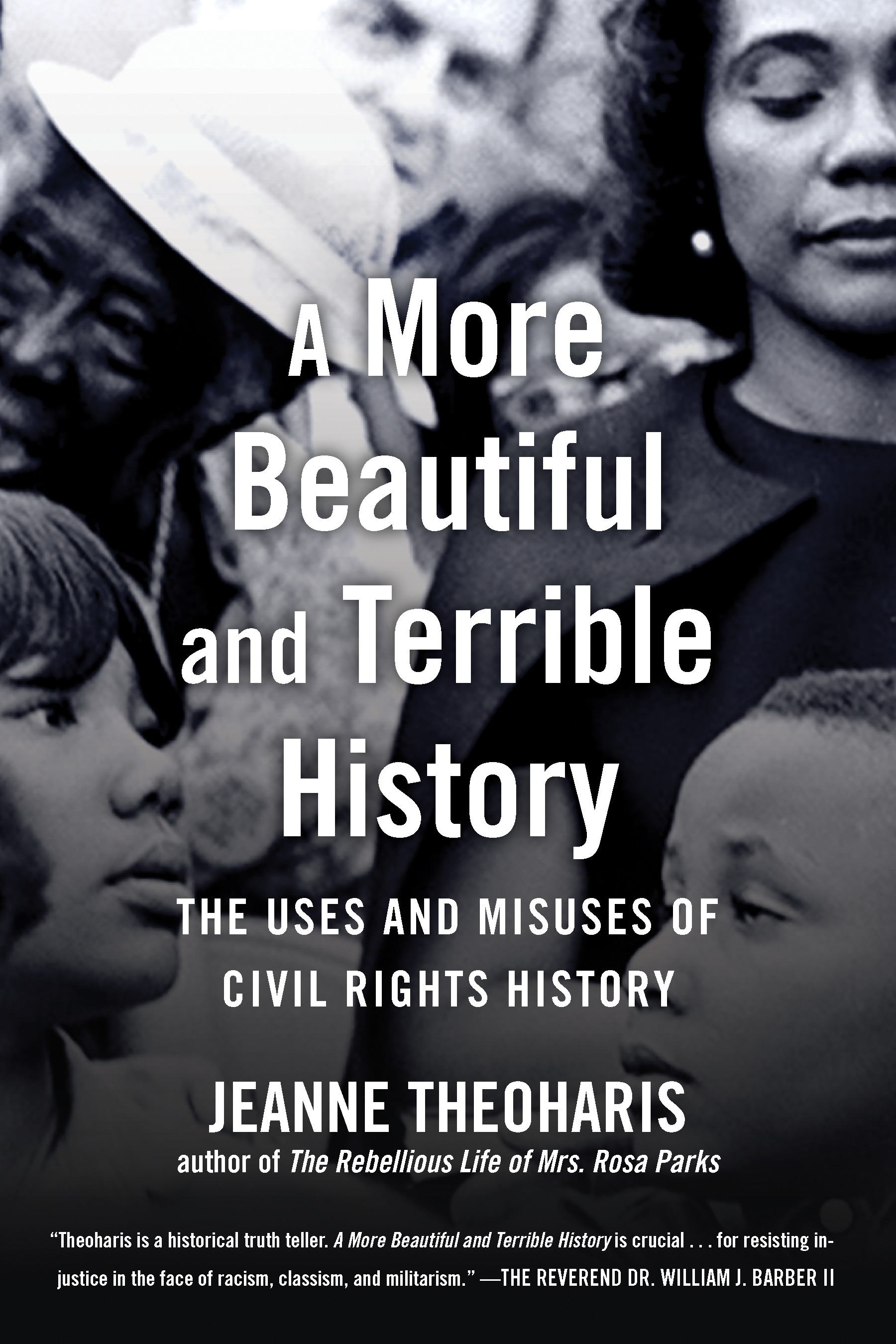
A More Beautiful and Terrible History Praised by The New York Times; O, The Oprah Magazine; Bitch Magazine; Slate; Publishers Weekly; and more, this is “a bracing corrective to a national mythology” (New York Times) around the civil rights movement. The civil rights movement has become national legend, lauded by presidents from Reagan to Obama to Trump, as proof of the power of American democracy. This fable, featuring dreamy heroes and accidental heroines, has shuttered the movement firmly in the past, whitewashed the forces that stood in its way, and diminished its scope. And it is used perniciously in our own times to chastise present-day movements and obscure contemporary injustice. In A More Beautiful and Terrible History award-winning historian Jeanne Theoharis dissects this national myth-making, teasing apart the accepted stories to show them in a strikingly different light. We see Rosa Parks not simply as a bus lady but a lifelong criminal justice activist and radical; Martin Luther King, Jr. as not only challenging Southern sheriffs but Northern liberals, too; and Coretta Scott King not only as a “helpmate” but a lifelong economic justice and peace activist who pushed her husband’s activism in these directions. Moving from “the histories we get” to “the histories we need,” Theoharis challenges nine key aspects of the fable to reveal the diversity of people, especially women and young people, who led the movement; the work and disruption it took; the role of the media and “polite racism” in maintaining injustice; and the immense barriers and repression activists faced. Theoharis makes us reckon with the fact that far from being acceptable, passive or unified, the civil rights movement was unpopular, disruptive, and courageously persevering. Activists embraced an expansive vision of justice—which a majority of Americans opposed and which the federal government feared. By showing us the complex reality of the movement, the power of its organizing, and the beauty and scope of the vision, Theoharis proves that there was nothing natural or inevitable about the progress that occurred. A More Beautiful and Terrible History will change our historical frame, revealing the richness of our civil rights legacy, the uncomfortable mirror it holds to the nation, and the crucial work that remains to be done. Winner of the 2018 Brooklyn Public Library Literary Prize in Nonfiction POLITICAL SCIENCE,Civil Rights

How Not to Get Shot NEW YORK TIMES BESTSELLER • A GOODREADS CHOICE AWARDS FINALIST "Hilarious yet soul-shaking." —Black Enterprise The fearless comedy legend—one of the “Original Kings of Comedyâ€â€”hilariously breaks down the wisdom of white people, advice that has been killing black folks in America for four hundred years and counting. 200 years ago, white people told black folks, “‘I suggest you pick the cotton if you don’t like getting whipped.†Today, it’s “comply with police orders if you don’t want to get shot.†Now comedian/activist D. L. Hughley–one the Original Kings of Comedy–confronts and remixes white people’s “advice†in this “hilarious examination of the current state of race relations in the United States†(Publishers Weekly). In America, a black man is three times more likely to be killed in encounters with police than a white guy. If only he had complied with the cop, he might be alive today, pundits say in the aftermath of the latest shooting of an unarmed black man. Or, Maybe he shouldn’t have worn that hoodie … or, moved more slowly … not been out so late … Wait, why are black people allowed to drive, anyway? This isn’t a new phenomenon. White people have been giving “advice†to black folks for as long as anyone can remember, telling them how to pick cotton, where to sit on a bus, what neighborhood to live in, when they can vote, and how to wear our pants. Despite centuries of whites’ advice, it seems black people still aren’t listening, and the results are tragic. Now, at last, activist, comedian, and New York Times bestselling author D. L. Hughley offers How Not to Get Shot, an illustrated how-to guide for black people, full of insight from white people, translated by one of the funniest black dudes on the planet. In these pages you will learn how to act, dress, speak, walk, and drive in the safest manner possible. You also will finally understand the white mind. It is a book that can save lives. Or at least laugh through the pain. Black people: Are you ready to not get shot! White people: Do you want to learn how to help the cause? Let’s go! POLITICAL SCIENCE,Civil Rights
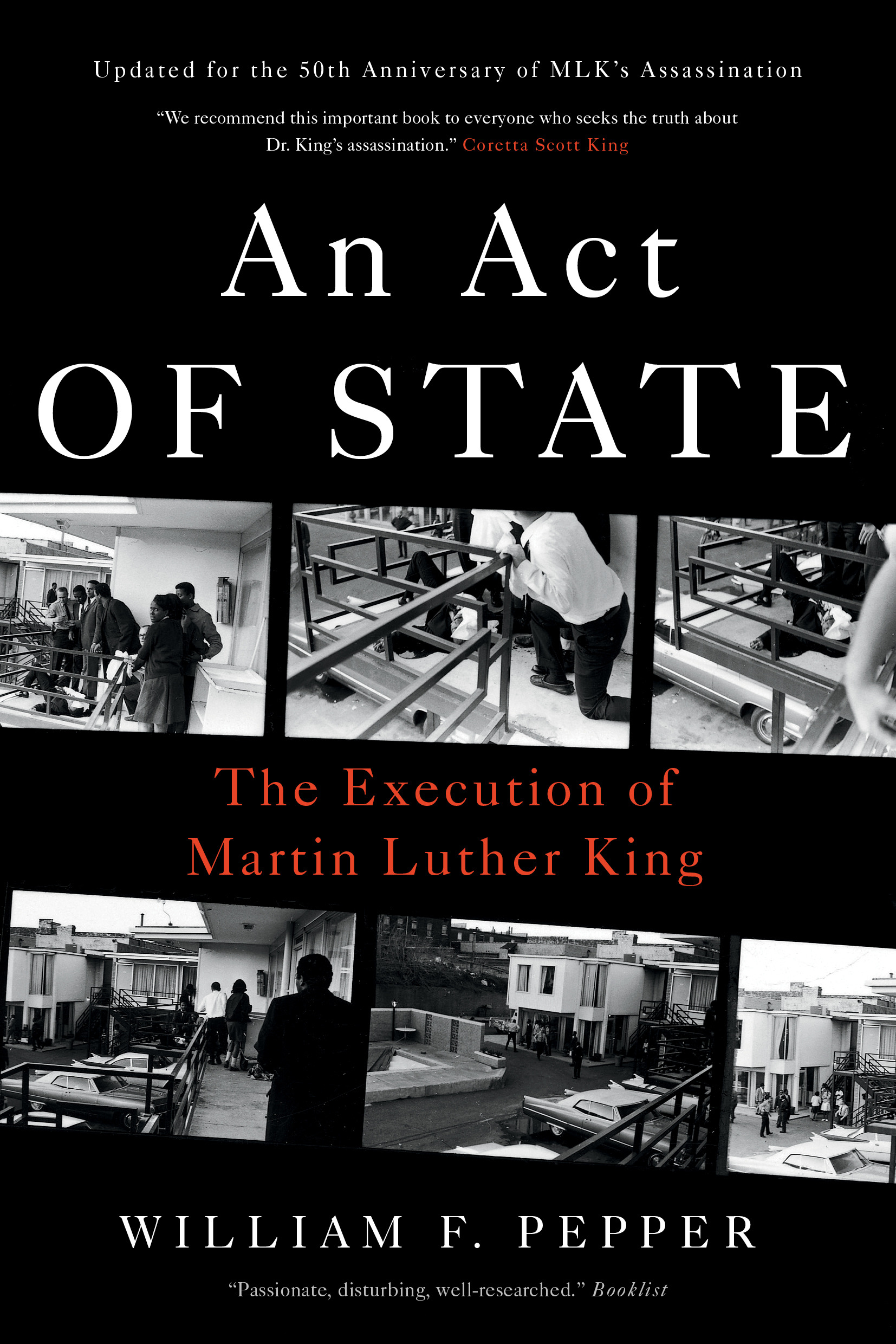
An Act of State The definitive account of Martin Luther King, Jr.’s assassination On April 4, 1968, Martin Luther King was in Memphis to support a workers’ strike. As night fell, army snipers took up position; military officers surveilled the scene from a nearby roof; and their accomplice, restaurant-owner Loyd Jowers, was ready to remove the murder weapon. When the dust had settled, King had been shot and a cleanup operation was in motion—James Earl Ray was framed, the crime scene was destroyed, and witnesses were killed. It would take William F. Pepper, attorney and friend of King, thirty years to get to the bottom of a conspiracy that changed the course of American history. In 1999, the King family, represented by the author, brought a civil action lawsuit against Loyd Jowers and other co-conspirators. Seventy witnesses set out the details of a plot that involved J. Edgar Hoover and the FBI, Richard Helms and the CIA, the US military, the Memphis police, and organized crime. The jury took an hour to find for the King family. Now fifty years after MLK’s execution, An Act of State demonstrates the bloody depths to which the US government will descend to repress a movement for change. POLITICAL SCIENCE,Civil Rights

Ella Baker and the Black Freedom Movement One of the most important African American leaders of the twentieth century and perhaps the most influential woman in the civil rights movement, Ella Baker (1903-1986) was an activist whose remarkable career spanned fifty years and touched thousands of lives. A gifted grassroots organizer, Baker shunned the spotlight in favor of vital behind-the-scenes work that helped power the black freedom struggle. She was a national officer and key figure in the National Association for the Advancement of Colored People, one of the founders of the Southern Christian Leadership Conference, and a prime mover in the creation of the Student Nonviolent Coordinating Committee. Baker made a place for herself in predominantly male political circles that included W. E. B. Du Bois, Thurgood Marshall, and Martin Luther King Jr., all the while maintaining relationships with a vibrant group of women, students, and activists both black and white. In this deeply researched biography, Barbara Ransby chronicles Baker's long and rich political career as an organizer, an intellectual, and a teacher, from her early experiences in depression-era Harlem to the civil rights movement of the 1950s and 1960s. Ransby shows Baker to be a complex figure whose radical, democratic worldview, commitment to empowering the black poor, and emphasis on group-centered, grassroots leadership set her apart from most of her political contemporaries. Beyond documenting an extraordinary life, the book paints a vivid picture of the African American fight for justice and its intersections with other progressive struggles worldwide across the twentieth century. POLITICAL SCIENCE,Civil Rights

How to Be an Antiracist #1 NEW YORK TIMES BESTSELLER • From the National Book Award–winning author of Stamped from the Beginning comes a “groundbreaking” (Time) approach to understanding and uprooting racism and inequality in our society—and in ourselves. “The most courageous book to date on the problem of race in the Western mind.”—The New York Times NAMED ONE OF THE BEST BOOKS OF THE YEAR BY The New York Times Book Review • Time • NPR • The Washington Post • Shelf Awareness • Library Journal • Publishers Weekly • Kirkus Reviews Antiracism is a transformative concept that reorients and reenergizes the conversation about racism—and, even more fundamentally, points us toward liberating new ways of thinking about ourselves and each other. At its core, racism is a powerful system that creates false hierarchies of human value; its warped logic extends beyond race, from the way we regard people of different ethnicities or skin colors to the way we treat people of different sexes, gender identities, and body types. Racism intersects with class and culture and geography and even changes the way we see and value ourselves. In How to Be an Antiracist, Kendi takes readers through a widening circle of antiracist ideas—from the most basic concepts to visionary possibilities—that will help readers see all forms of racism clearly, understand their poisonous consequences, and work to oppose them in our systems and in ourselves. Kendi weaves an electrifying combination of ethics, history, law, and science with his own personal story of awakening to antiracism. This is an essential work for anyone who wants to go beyond the awareness of racism to the next step: contributing to the formation of a just and equitable society. Praise for How to Be an Antiracist “Ibram X. Kendi’s new book, How to Be an Antiracist, couldn’t come at a better time. . . . Kendi has gifted us with a book that is not only an essential instruction manual but also a memoir of the author’s own path from anti-black racism to anti-white racism and, finally, to antiracism. . . . How to Be an Antiracist gives us a clear and compelling way to approach, as Kendi puts it in his introduction, ‘the basic struggle we’re all in, the struggle to be fully human and to see that others are fully human.’ ”—NPR “Kendi dissects why in a society where so few people consider themselves to be racist the divisions and inequalities of racism remain so prevalent. How to Be an Antiracist punctures the myths of a post-racial America, examining what racism really is—and what we should do about it.”—Time POLITICAL SCIENCE,Civil Rights
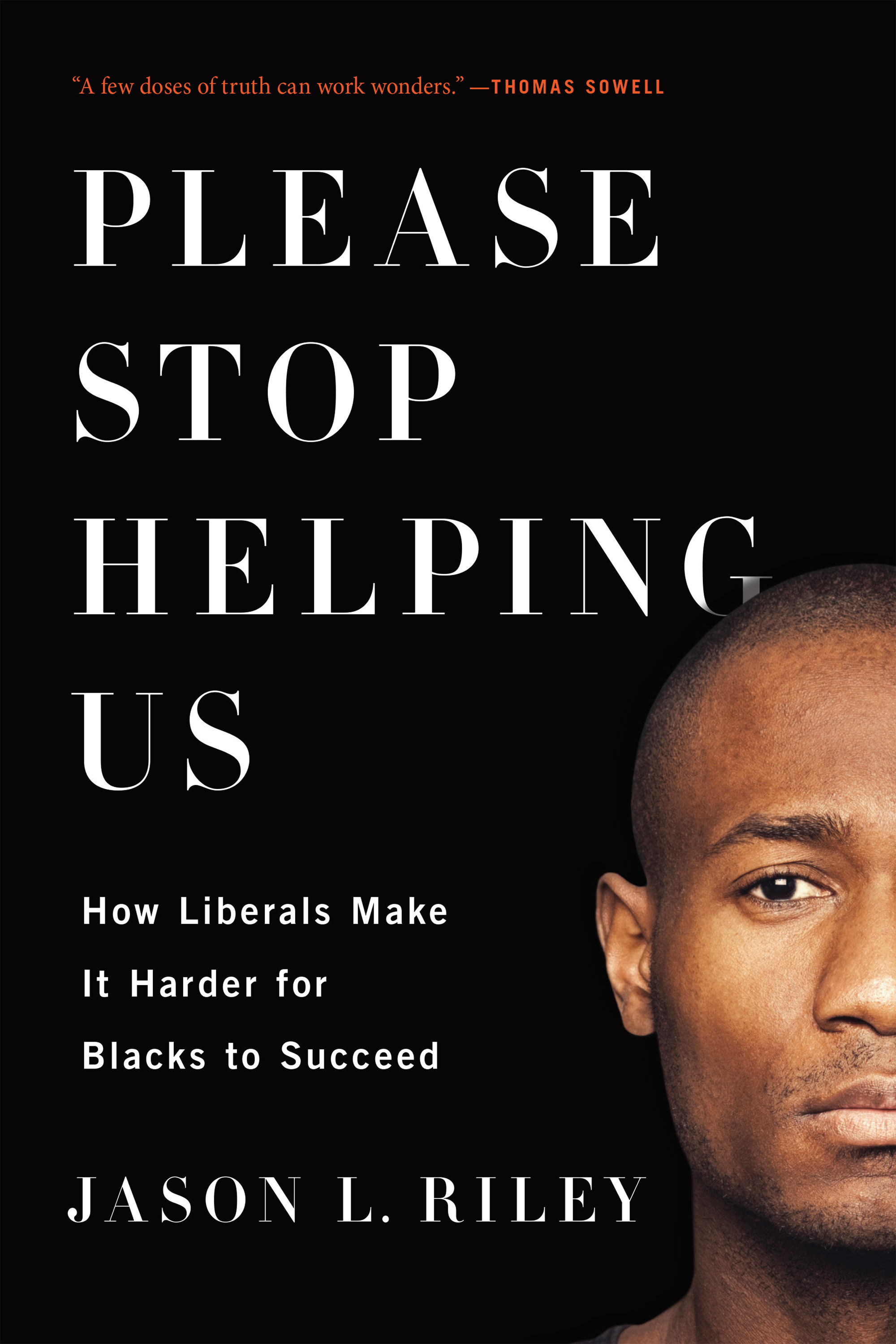
Please Stop Helping Us Why is it that so many efforts by liberals to lift the black underclass not only fail, but often harm the intended beneficiaries? In Please Stop Helping Us, Jason L. Riley examines how well-intentioned welfare programs are in fact holding black Americans back. Minimum-wage laws may lift earnings for people who are already employed, but they price a disproportionate number of blacks out of the labor force. Affirmative action in higher education is intended to address past discrimination, but the result is fewer black college graduates than would otherwise exist. And so it goes with everything from soft-on-crime laws, which make black neighborhoods more dangerous, to policies that limit school choice out of a mistaken belief that charter schools and voucher programs harm the traditional public schools that most low-income students attend. In theory these efforts are intended to help the poor—and poor minorities in particular. In practice they become massive barriers to moving forward. Please Stop Helping Us lays bare these counterproductive results. People of goodwill want to see more black socioeconomic advancement, but in too many instances the current methods and approaches aren’t working. Acknowledging this is an important first step. POLITICAL SCIENCE,Civil Rights

The War on Cops Violent crime has been rising sharply in many American cities after two decades of decline. Homicides jumped nearly 17 percent in 2015 in the largest 50 cities, the biggest one-year increase since 1993. The reason is what Heather Mac Donald first identified nationally as the “Ferguson effectâ€: Since the 2014 police shooting death of Michael Brown in Ferguson, Missouri, officers have been backing off of proactive policing, and criminals are becoming emboldened. This book expands on Mac Donald’s groundbreaking and controversial reporting on the Ferguson effect and the criminal-justice system. It deconstructs the central narrative of the Black Lives Matter movement: that racist cops are the greatest threat to young black males. On the contrary, it is criminals and gangbangers who are responsible for the high black homicide death rate. The War on Cops exposes the truth about officer use of force and explodes the conceit of “mass incarceration.†A rigorous analysis of data shows that crime, not race, drives police actions and prison rates. The growth of proactive policing in the 1990s, along with lengthened sentences for violent crime, saved thousands of minority lives. In fact, Mac Donald argues, no government agency is more dedicated to the proposition that “black lives matter†than today’s data-driven, accountable police department. Mac Donald gives voice to the many residents of high-crime neighborhoods who want proactive policing. She warns that race-based attacks on the criminal-justice system, from the White House on down, are eroding the authority of law and putting lives at risk. This book is a call for a more honest and informed debate about policing, crime, and race. POLITICAL SCIENCE,Civil Rights
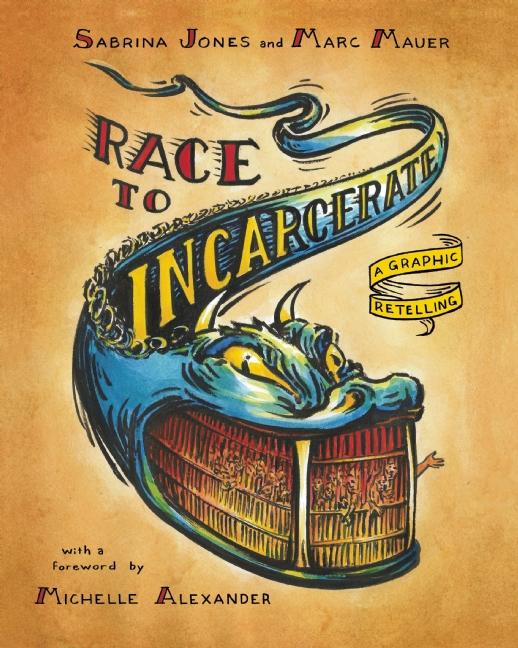
Race to Incarcerate "Do not underestimate the power of the book you are holding in your hands."Michelle Alexander More than 2 million people are now imprisoned in the United States, producing the highest rate of incarceration in the world. How did this happen? As the director of The Sentencing Project, Marc Mauer has long been one of the country’s foremost experts on sentencing policy, race, and the criminal justice system. His book Race to Incarcerate has become the essential text for understanding the exponential growth of the U.S. prison system; Michelle Alexander, author of the bestselling The New Jim Crow, calls it "utterly indispensable." Now, Sabrina Jones, a member of the World War 3 Illustrated collective and an acclaimed author of politically engaged comics, has collaborated with Mauer to adapt and update the original book into a vivid and compelling comics narrative. Jones's dramatic artwork adds passion and compassion to the complex story of the penal system’s shift from rehabilitation to punishment and the ensuing four decades of prison expansion, its interplay with the devastating "War on Drugs," and its corrosive effect on generations of Americans. With a preface by Mauer and a foreword by Alexander, Race to Incarcerate: A Graphic Retelling presents a compelling argument about mass incarceration’s tragic impact on communities of colorif current trends continue, one of every three black males and one of every six Latino males born today can expect to do time in prison. The race to incarcerate is not only a failed social policy, but also one that prevents a just, diverse society from flourishing. POLITICAL SCIENCE,Civil Rights
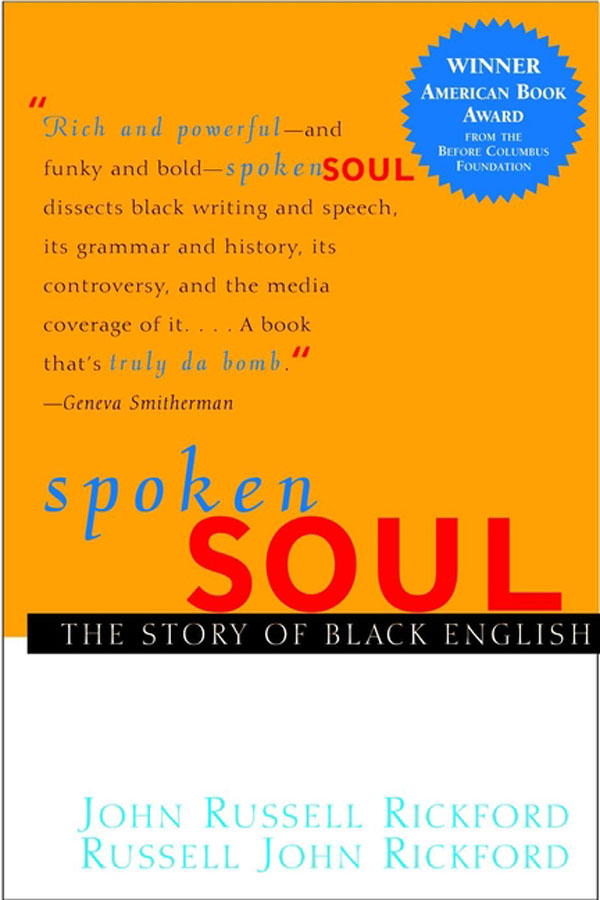
Spoken Soul In Praise of Spoken Soul: The Story of Black English "Spoken Soul brilliantly fills a huge gap. . . . a delightfully readable introduction to the elegant interweave between the language and its culture."–Ralph W. Fasold, Georgetown university"A lively, well-documented history of Black English . . . that will enlighten and inform not only educators, for whom it should be required reading, but all who value and question language."– Kirkus Reviews "Spoken Soul is a must read for anyone who is interested in the connection between language and identity."– Chicago Defender Claude Brown called Black English "Spoken Soul." Toni Morrison said, "It's a love, a passion. Its function is like a preacher’s: to make you stand out of your seat, make you lose yourself and hear yourself. The worst of all possible things that could happen would be to lose that language."Now renowned linguist John R. Rickford and journalist Russell J. Rickford provide the definitive guide to African American vernacular English–from its origins and features to its powerful fascination for society at large. POLITICAL SCIENCE,Civil Rights

How to Fight Anti-Semitism The prescient former New York Times writer delivers an urgent wake-up call to all Americans exposing the alarming rise of anti-Semitism in this country—and explains what we can do to defeat it. WINNER OF THE NATIONAL JEWISH BOOK AWARD • “Stunning . . . Bari Weiss is heroic, fearless, brilliant and big-hearted. Most importantly, she is right.”—Lisa Taddeo, #1 New York Times bestselling author of Three Women On October 27, 2018, eleven Jews were gunned down as they prayed at their synagogue in Pittsburgh. It was the deadliest attack on Jews in American history. For most Americans, the massacre at Tree of Life, the synagogue where Bari Weiss became a bat mitzvah, came as a total shock. But anti-Semitism is the oldest hatred, commonplace across the Middle East and on the rise for years in Europe. So that terrible morning in Pittsburgh raised a question Americans can no longer avoid: Could it happen here? This book is Weiss’s answer. Like many, Weiss long believed this country could escape the rising tide of anti-Semitism. With its promise of free speech and religion, its insistence that all people are created equal, its tolerance for difference, and its emphasis on shared ideals rather than bloodlines, America has been, even with all its flaws, a new Jerusalem for the Jewish people. But now the luckiest Jews in history are beginning to face a three-headed dragon known all too well to Jews of other times and places: the physical fear of violent assault, the moral fear of ideological vilification, and the political fear of resurgent fascism and populism. No longer the exclusive province of the far right, the far left, and assorted religious bigots, anti-Semitism now finds a home in identity politics as well as the reaction against identity politics, in the renewal of America First isolationism and the rise of one-world socialism, and in the spread of Islamist ideas into unlikely places. A hatred that was, until recently, reliably taboo is migrating toward the mainstream, amplified by social media and a culture of conspiracy that threatens us all. Weiss is one of our most provocative writers, and her cri de couer makes a powerful case for renewing Jewish and American values in this uncertain moment. Not just for the sake of America’s Jews, but for the sake of America. POLITICAL SCIENCE,Civil Rights

America Is Better Than This An exposé and cry of outrage at the cruelty and chaos the Trump administration has wrought at the border with child separations, border blockades, and a massive gulag of child prisons housing thousands. p.p1 {margin: 0.0px 0.0px 0.0px 0.0px; font: 12.0px 'Times New Roman'} p.p2 {margin: 0.0px 0.0px 0.0px 0.0px; text-indent: 36.0px; font: 12.0px 'Times New Roman'} Jeff Merkley couldn't believe his eyes. He never dreamed the United States could treat vulnerable young families with such calculated brutality. Few had witnessed what Merkley discovered just by showing up at the border and demanding to see what was going on behind closed doors. Contrary to the official stories and soothing videos, he found mothers and children, newborn babies and infants, stranded for days on border bridges in blistering heat or locked up in ice-cold holding pens. There were nearly 1,500 boys jammed into a former Walmart, a child tent prison in the desert with almost 3,000 boys and girls, and children struggling to survive in gang-filled Mexican border towns after they were blocked from seeking asylum in the United States. Worst of all, there were the children ripped out of their parents' arms and sorted into cages in some profoundly warped attempt to discourage migration. This was how the Trump administration treated the child victims of unspeakable violence that had driven them from their homes: as pawns in a power play rather than as humans worthy of respect and dignity. It was Merkley's visits -- captured live on viral video -- that triggered worldwide outrage at the forced separation of children from their parents. Just by taking an interest -- by caring about the people legally claiming asylum at America's borders -- Merkley helped expose the Trump administration's war on migrant families. Along the way, he helped turn the tide against some of its worst excesses. AMERICA IS BETTER THAN THIS tells the inside story of how one senator, with no background as an immigration activist, became a leading advocate for reform of the brutal policies that have created a humanitarian crisis on the southern U.S. border. It represents the heartfelt and candid voice of a concerned American who believes his country stands for something far bigger and better. POLITICAL SCIENCE,Civil Rights

We Keep Us Safe A groundbreaking new vision for public safety that overturns more than 200 years of fear-based discrimination, othering, and punishment As the effects of aggressive policing and mass incarceration harm historically marginalized communities and tear families apart, how do we define safety? In a time when the most powerful institutions in the United States are embracing the repressive and racist systems that keep many communities struggling and in fear, we need to reimagine what safety means. Community leader and lawyer Zach Norris lays out a radical way to shift the conversation about public safety away from fear and punishment and toward growth and support systems for our families and communities. In order to truly be safe, we are going to have to dismantle our mentality of Us vs. Them. By bridging the divides and building relationships with one another, we can dedicate ourselves to strategic, smart investments—meaning resources directed toward our stability and well-being, like healthcare and housing, education and living-wage jobs. This is where real safety begins. We Keep Us Safe is a blueprint of how to hold people accountable while still holding them in community. The result reinstates full humanity and agency for everyone who has been dehumanized and traumatized, so they can participate fully in life, in society, and in the fabric of our democracy. POLITICAL SCIENCE,Civil Rights

'White Girl Bleed A Lot' Ferguson might be the worst, but it is not the first. Ferguson is just the latest of hundreds of examples of black mob violence around the country. White Girl Bleed a Lot: The Return of Racial Violence and How the Media Ignore It was written for the deniers: Reporters and public officials and others who deny black mob violence has reached epidemic levels. That is why so many readers get another copy: They send it to someone who needs to read it. Denial is not an option any more. Many of these cases are now on YouTube. And for the first time, readers will be able to scan QR codes to follow the black mob violence on video as they read about it in the book. For the first time, readers will be able to see the huge difference between what big city newspapers say is happening. And what the videos show is really happening. White Girl Bleed a Lot documents more than five hundred cases of black mob violence in more than one hundred cities around the country. Many in 2013. And how the local and national media ignore, excuse and even condone it. White Girl Bleed a Lot documents black mob violence in the bigger cities, such as Baltimore, Philadelphia, Chicago, New York, St. Louis. But also in places where the frequency and intensity of racial violence is not as well known: Milwaukee, Indianapolis, Charlotte, Seattle, Portland, Denver, Las Vegas, Kansas City, Peoria, Springfield, Greensboro, Des Moines, Cedar Rapids, Champaign, Madison and many more. Readers learn about "Beat Whitey Night" at a Midwest state fair. Or how a Chicago Police Chief blamed the violence on Sarah Palin and the Pilgrims. Or how Oprah Winfrey gave $1 million to a Philadelphia charter school, only to see its students on video assaulting a white person shortly thereafter. Or how gays and Asians and women are particular targets. And how one congressman and former mayor said his city should not crack down on the violence because that will "just make a lot of black kids angry." And how newspaper editors and reporters say they will not report racial violence. And how some people fight back. Praised by national talk show host Jesse Lee Peterson. The San Francisco Examiner gave it 5 Stars. More reviews at WhiteGirlBleedaLot.com Colin Flaherty has won more than fifty awards for journalism, many from the Society of Professional Journalists. His story about a black man unjustly convicted of trying to kill his wife girl friend resulted in his release from state prison and was featured on NPR, the Los Angeles Times and Court TV. POLITICAL SCIENCE,Civil Rights
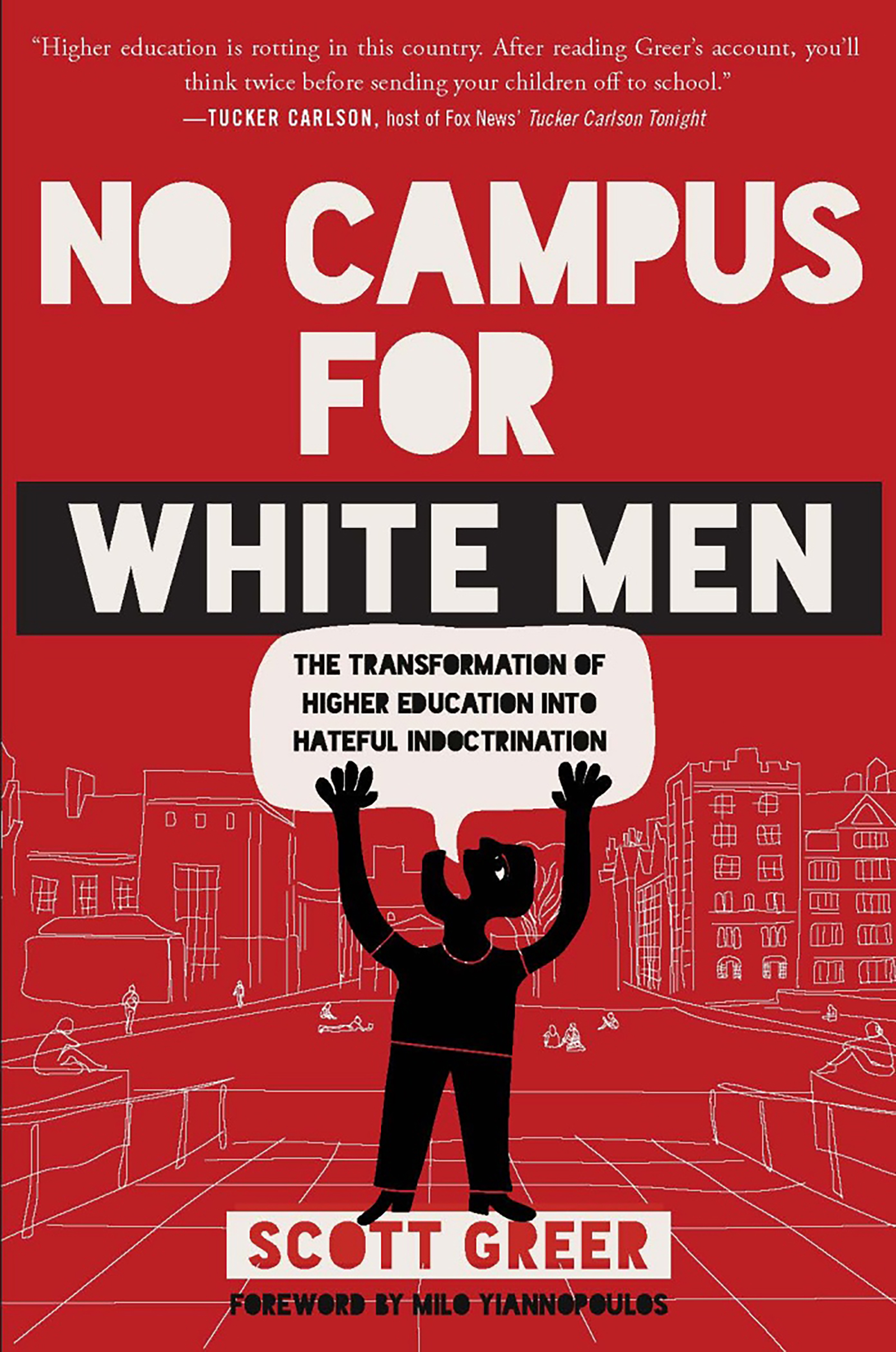
No Campus for White Men No Campus for White Men shines a bright light on the growing obsession with diversity, victimization and identity politics on today's college campuses, and shows how it is creating an intensely hostile and fearful atmosphere that can only lead, ultimately, to ever greater polarization in American society. Across the country, ugly campus protests over speakers with dissenting viewpoints, as well as a preoccupation with "micro-aggressions," "trigger warnings," "safe spaces" and brand-new "gender identities," make it obvious that something has gone terribly wrong with higher education. For years, colleges have pursued policies favoring students based not on their merit, but on their race, gender, and sexual orientation. The disturbingly negative effects of this culture are now impossible to deny. Scott Greer’s investigative work links such seemingly unrelated trends as "rape culture" hysteria and Black Lives Matter to an overall campus mindset intent on elevating and celebrating leftist-designated "protected classes" above everyone else – while intimidating, censoring, and punishing those who disagree with this perversely un-American agenda. In No Campus for White Men, Greer broadens the usual media focus well beyond coverage of demonstrations by easily offended college students, to spotlight the darker forces at work behind the scenes that are feeding higher education’s metastasizing crisis – and how all this results in sustained animosity, first and foremost, toward white men. Greer also documents how this starkly totalitarian culture is not isolated to higher education, but is rather a result of trends already operating in society. Thus, he shows, today's campus madness may eventually dominate much more of America if it is not addressed and reversed soon. POLITICAL SCIENCE,Civil Rights
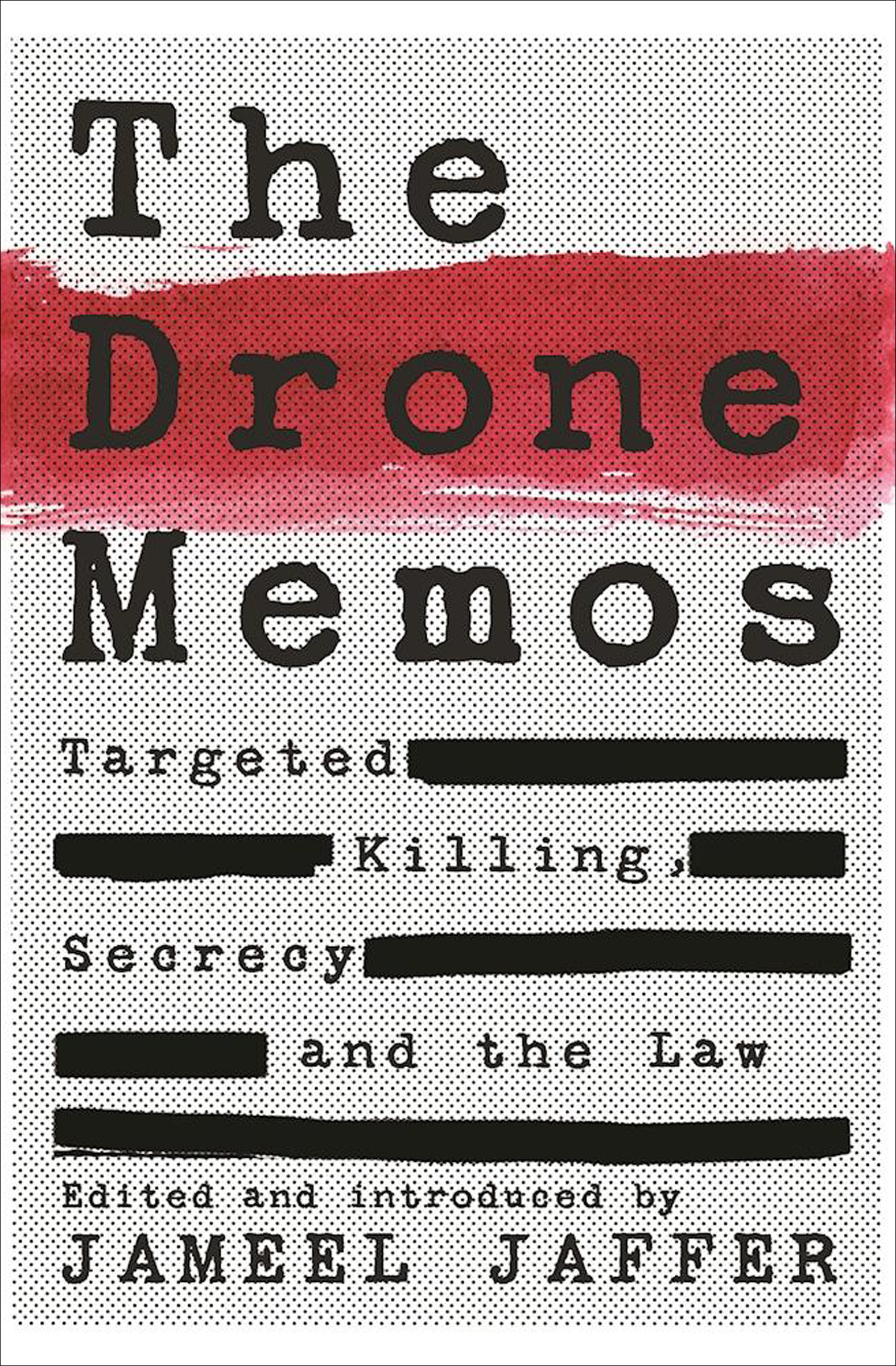
The Drone Memos “A trenchant summation†and analysis of the legal rationales behind the US drone policy of targeted killing of suspected terrorists, including US citizens (Publishers Weekly, starred review). In the long response to 9/11, the US government initiated a deeply controversial policy of “targeted killingâ€â€”the extrajudicial execution of suspected terrorists and militants, typically via drones. A remarkable effort was made to legitimize this practice; one that most human rights experts agree is illegal and that the United States has historically condemned. In The Drone Memos, civil rights lawyer Jameel Jaffer presents and assesses the legal memos and policy documents that enabled the Obama administration to put this program into action. In a lucid and provocative introduction, Jaffer, who led the ACLU legal team that secured the release of many of the documents, evaluates the drone memos in light of domestic and international law. He connects the documents’ legal abstractions to the real-world violence they allow, and makes the case that we are trading core principles of democracy and human rights for the illusion of security. “A careful study of a secretive counterterrorism infrastructure capable of sustaining endless, orderless war, this book is profoundly necessary.†—Katrina vanden Heuvel, editor and publisher of The Nation POLITICAL SCIENCE,Civil Rights
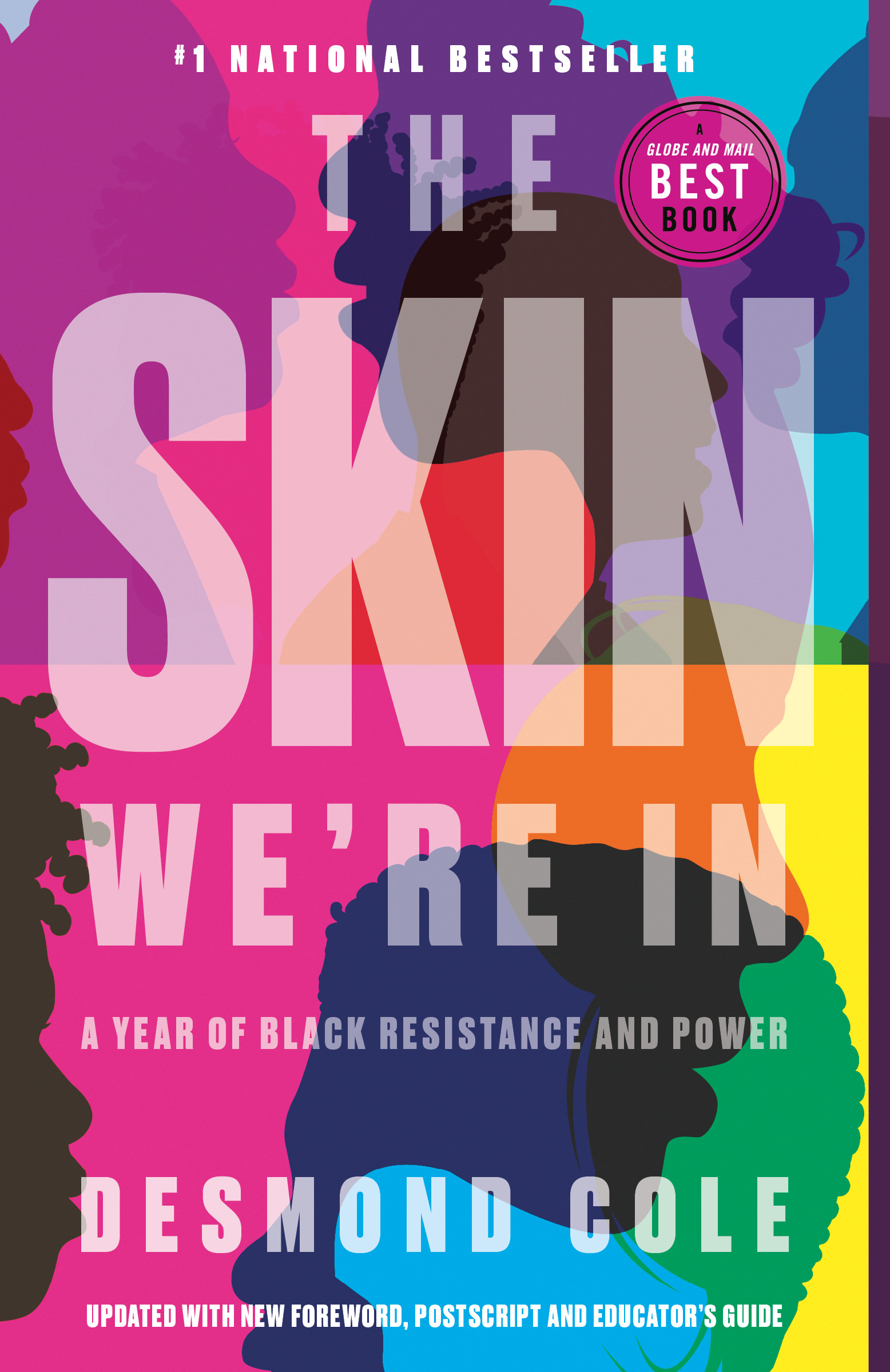
The Skin We're In NATIONAL BESTSELLER A bracing, provocative, and perspective-shifting book from one of Canada's most celebrated and uncompromising writers, Desmond Cole. The Skin We're In will spark a national conversation, influence policy, and inspire activists. In his 2015 cover story for Toronto Life magazine, Desmond Cole exposed the racist actions of the Toronto police force, detailing the dozens of times he had been stopped and interrogated under the controversial practice of carding. The story quickly came to national prominence, shaking the country to its core and catapulting its author into the public sphere. Cole used his newfound profile to draw insistent, unyielding attention to the injustices faced by Black Canadians on a daily basis. Both Cole’s activism and journalism find vibrant expression in his first book, The Skin We’re In. Puncturing the bubble of Canadian smugness and naive assumptions of a post-racial nation, Cole chronicles just one year—2017—in the struggle against racism in this country. It was a year that saw calls for tighter borders when Black refugees braved frigid temperatures to cross into Manitoba from the States, Indigenous land and water protectors resisting the celebration of Canada’s 150th birthday, police across the country rallying around an officer accused of murder, and more. The year also witnessed the profound personal and professional ramifications of Desmond Cole’s unwavering determination to combat injustice. In April, Cole disrupted a Toronto police board meeting by calling for the destruction of all data collected through carding. Following the protest, Cole, a columnist with the Toronto Star, was summoned to a meeting with the paper’s opinions editor and informed that his activism violated company policy. Rather than limit his efforts defending Black lives, Cole chose to sever his relationship with the publication. Then in July, at another police board meeting, Cole challenged the board to respond to accusations of a police cover-up in the brutal beating of Dafonte Miller by an off-duty police officer and his brother. When Cole refused to leave the meeting until the question was publicly addressed, he was arrested. The image of Cole walking out of the meeting, handcuffed and flanked by officers, fortified the distrust between the city’s Black community and its police force. Month-by-month, Cole creates a comprehensive picture of entrenched, systemic inequality. Urgent, controversial, and unsparingly honest, The Skin We’re In is destined to become a vital text for anti-racist and social justice movements in Canada, as well as a potent antidote to the all-too-present complacency of many white Canadians. POLITICAL SCIENCE,Civil Rights
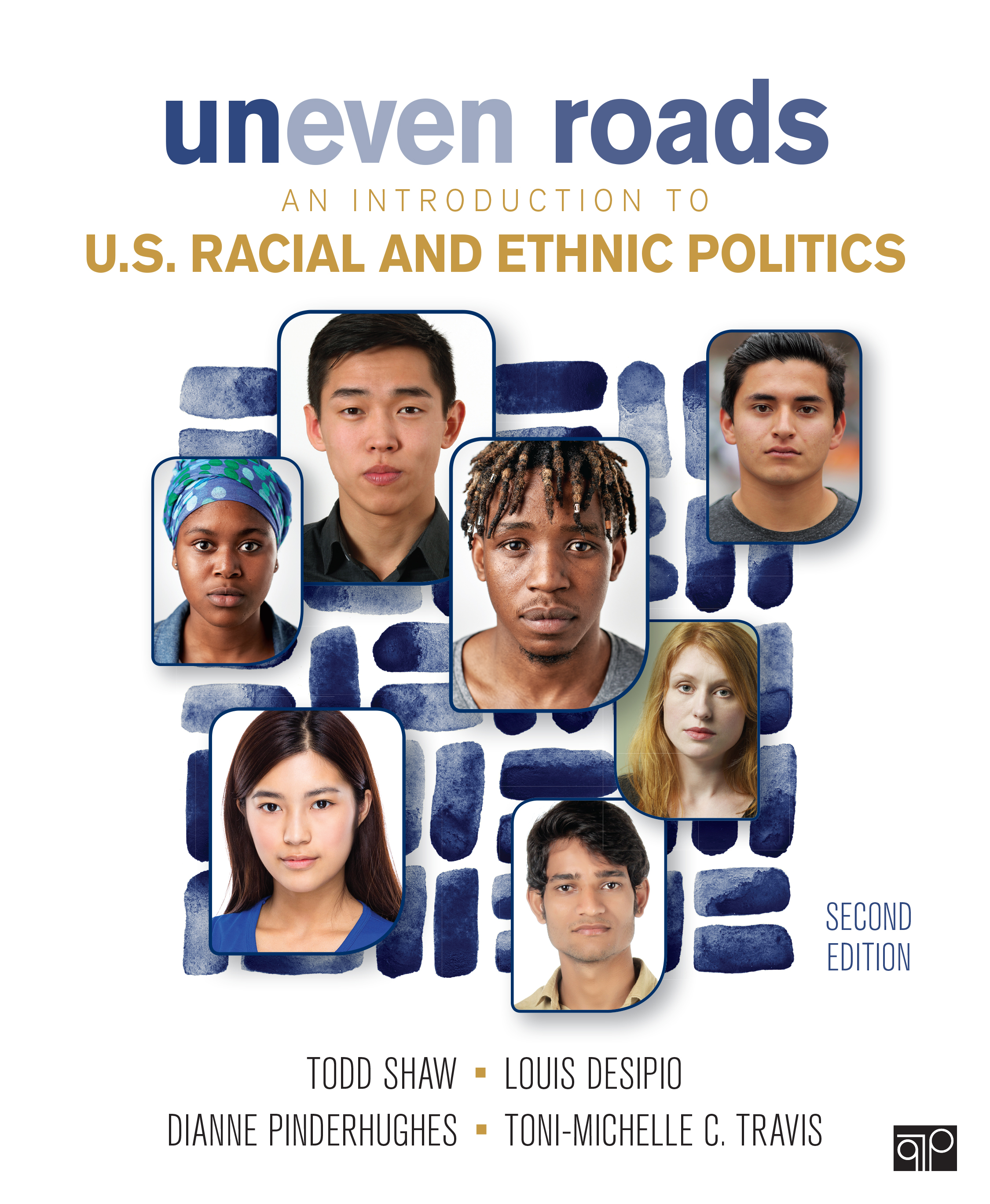
Uneven Roads Uneven Roads helps you grasp how, when, and why race and ethnicity matter in U.S. politics. Using the metaphor of a road, with twists, turns, and dead ends, this incisive text takes you on a journey to understanding political racialization and the roots of modern interpretations of race and ethnicity. The book’s structure and narrative are designed to encourage comparison and reflection. You will critically analyze the history and context of U.S. racial and ethnic politics to build the skills needed to draw your own conclusions. In the Second Edition of this groundbreaking text , authors Shaw , DeSipio , Pinderhughes , and Travis bring the historical narrative to life by addressing the most contemporary debates and challenges affecting U.S. racial and ethnic politics. You will explore important issues regarding voting rights, political representation, education and criminal justice policies, and the immigrant experience. A revised final chapter on intersectionality encourages you to examine how groups go beyond the boundaries of race and ethnicity to come together on matters of class, gender, and sexuality. POLITICAL SCIENCE,Civil Rights

The Short Life and Curious Death of Free Speech in America The critically acclaimed journalist and bestselling author of The Rage of a Privileged Class explores one of the most essential rights in America—free speech—and reveals how it is crumbling under the combined weight of polarization, technology, money and systematized lying in this concise yet powerful and timely book. Named one of Newsweek’s "25 Must-Read Fall Fiction and Nonfiction Books to Escape the Chaos of 2020" Free speech has long been one of American's most revered freedoms. Yet now, more than ever, free speech is reshaping America’s social and political landscape even as it is coming under attack. Bestselling author and critically acclaimed journalist Ellis Cose wades into the debate to reveal how this Constitutional right has been coopted by the wealthy and politically corrupt. It is no coincidence that historically huge disparities in income have occurred at times when moneyed interests increasingly control political dialogue. Over the past four years, Donald Trump’s accusations of “fake news,†the free use of negative language against minority groups, “cancel culture,†and blatant xenophobia have caused Americans to question how far First Amendment protections can—and should—go. Cose offers an eye-opening wholly original examination of the state of free speech in America today, litigating ideas that touch on every American’s life. Social media meant to bring us closer, has become a widespread disseminator of false information keeping people of differing opinions and political parties at odds. The nation—and world—watches in shock as white nationalism rises, race and gender-based violence spreads, and voter suppression widens. The problem, Cose makes clear, is that ordinary individuals have virtually no voice at all. He looks at the danger of hyper-partisanship and how the discriminatory structures that determine representation in the Senate and the electoral college threaten the very concept of democracy. He argues that the safeguards built into the Constitution to protect free speech and democracy have instead become instruments of suppression by an unfairly empowered political minority. But we can take our rights back, he reminds us. Analyzing the experiences of other countries, weaving landmark court cases together with a critical look at contemporary applications, and invoking the lessons of history, including the Great Migration, Cose sheds much-needed light on this cornerstone of American culture and offers a clarion call for activism and change. POLITICAL SCIENCE,Civil Rights

Identity Politics in the United States In 2017, a white supremacist rally at the University of Virginia forced many to consider how much progress had been made in a country that, nine years prior, had elected its first Black president. Beyond these racial flashpoints, the increasingly polarized nature of US politics has reignited debates around the meaning of identity, citizenship, and acceptance in America today. In this pioneering book, Khalilah L. Brown-Dean moves beyond the headlines to examine how contemporary controversies emanate from longstanding struggles over power, access, and belonging. Using intersectionality as an organizing framework, she draws on current tensions such as voter suppression, the Me Too movement, the Standing Rock protests, marriage equality, military service, the rise of the Religious Right, protests by professional athletes, and battles over immigration to show how conflicts over group identity are an inescapable feature of American political development. Brown-Dean explores issues of citizenship, race, ethnicity, gender, sexual identity, and religion to argue that democracy in the United States is built upon the battle of ideas related to how we see ourselves, how we see others, and the mechanisms available to reinforce those distinctions. Identity Politics in the United States will be an essential resource for students and engaged citizens who want to understand the link between historical context, contemporary political challenges, and paths to move toward a stronger democracy. POLITICAL SCIENCE,Civil Rights
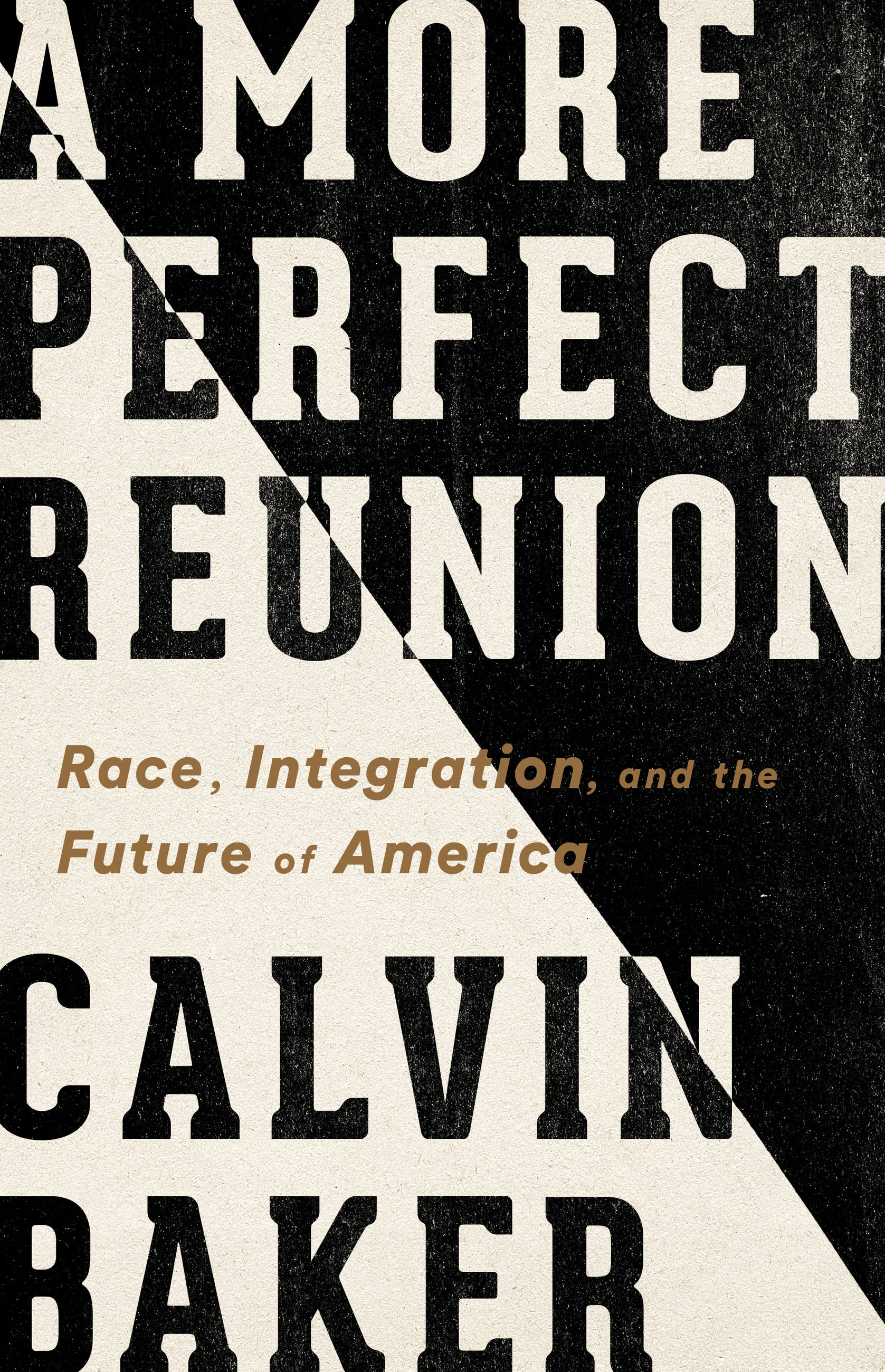
A More Perfect Reunion A provocative case for integration as the single most radical, discomfiting idea in America, yet the only enduring solution to the racism that threatens our democracy. Americans have prided ourselves on how far we've come from slavery, lynching, and legal segregation-measuring ourselves by incremental progress instead of by how far we have to go. But fifty years after the last meaningful effort toward civil rights, the US remains overwhelmingly segregated and unjust. Our current solutions -- diversity, representation, and desegregation -- are not enough. As acclaimed writer Calvin Baker argues in this bracing, necessary book, we first need to envision a society no longer defined by the structures of race in order to create one. The only meaningful remedy is integration: the full self-determination and participation of all African-Americans, and all other oppressed groups, in every facet of national life. This is the deepest threat to the racial order and the real goal of civil rights. At once a profound, masterful reading of US history from the colonial era forward and a trenchant critique of the obstacles in our current political and cultural moment, A More Perfect Reunion is also a call to action. As Baker reminds us, we live in a revolutionary democracy. We are one of the best-positioned generations in history to finish that revolution. POLITICAL SCIENCE,Civil Rights

Youth to Power "Jamie Margolin is among the powerful and inspiring youth activists leading a movement to demand urgent action on the climate crisis. With determined purpose and moral clarity, Jamie is pushing political leaders to develop ambitious plans to confront this existential threat to humanity. Youth To Power is an essential how-to for anyone of any age who feels called to act to protect our planet for future generations." --- Former Vice President Al Gore Climate change activist and Zero Hour cofounder Jamie Margolin offers the essential guide to changemaking for young people. The 1963 Children's March. The 2016 Dakota Access Pipeline protests. March for Our Lives, and School Strike for Climate. What do all these social justice movements have in common? They were led by passionate, informed, engaged young people. Jamie Margolin has been organizing and protesting since she was fourteen years old. Now the co-leader of a global climate action movement, she knows better than most how powerful a young person can be. You don't have to be able to vote or hold positions of power to change the world. In Youth to Power, Jamie presents the essential guide to changemaking, with advice on writing and pitching op-eds, organizing successful events and peaceful protests, time management as a student activist, utilizing social and traditional media to spread a message, and sustaining long-term action. She features interviews with prominent young activists including Tokata Iron Eyes of the #NoDAPL movement and Nupol Kiazolu of the #BlackLivesMatter movement, who give guidance on handling backlash, keeping your mental health a priority, and how to avoid getting taken advantage of. Jamie walks readers through every step of what effective, healthy, intersectional activism looks like. Young people have a lot to say, and Youth to Power will give you the tools to raise your voice. POLITICAL SCIENCE,Civil Rights
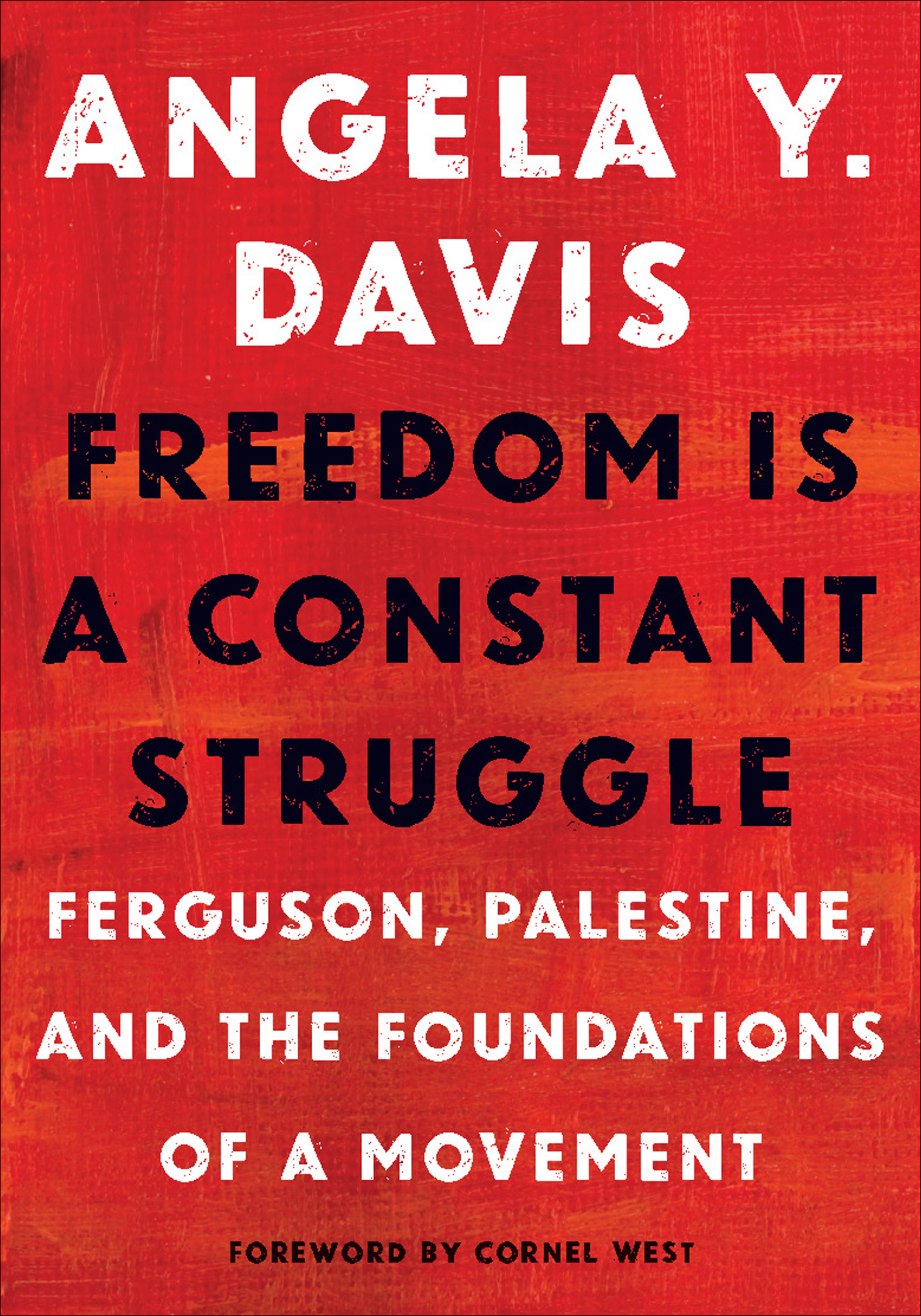
Freedom Is a Constant Struggle In this collection of essays, interviews, and speeches, the renowned activist examines today’s issues—from Black Lives Matter to prison abolition and more. Activist and scholar Angela Y. Davis has been a tireless fighter against oppression for decades. Now, the iconic author of Women, Race, and Class offers her latest insights into the struggles against state violence and oppression throughout history and around the world. Reflecting on the importance of black feminism, intersectionality, and prison abolitionism, Davis discusses the legacies of previous liberation struggles, from the Black Freedom Movement to the South African anti-Apartheid movement. She highlights connections and analyzes today’s struggles against state terror, from Ferguson to Palestine. Facing a world of outrageous injustice, Davis challenges us to imagine and build a movement for human liberation. And in doing so, she reminds us that “freedom is a constant struggle.†This edition of Freedom Is a Constant Struggle includes a foreword by Dr. Cornel West and an introduction by Frank Barat. POLITICAL SCIENCE,Civil Rights
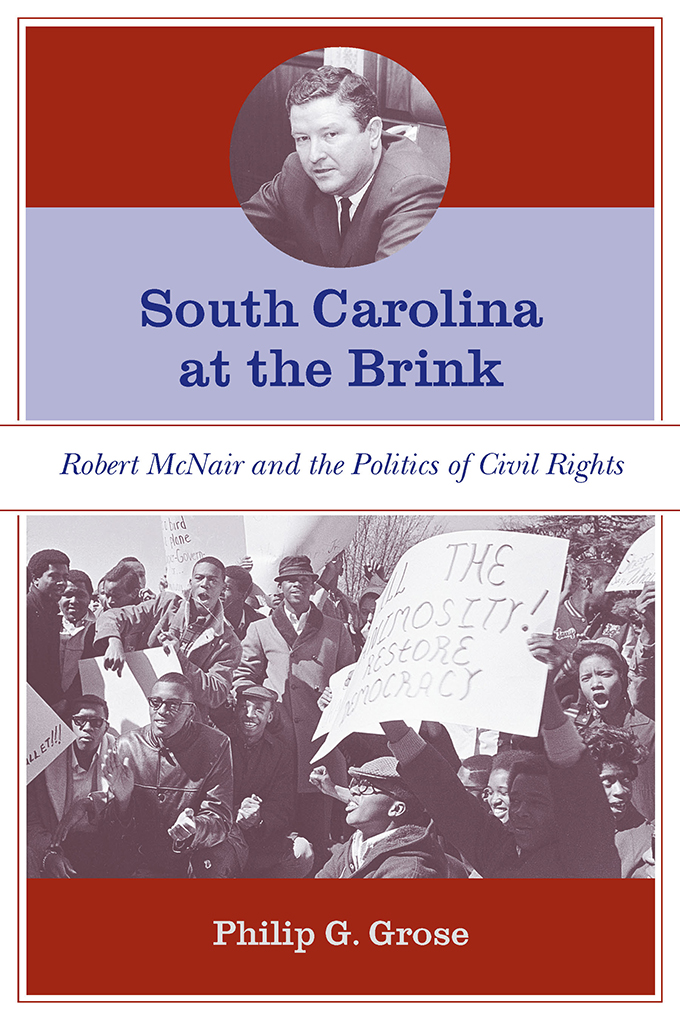
South Carolina at the Brink Grose's narrative draws from an extensive oral history project on the McNair administration conducted by the University of South Carolina and the South Carolina Department of Archives and History as well as recent interviews with key participants. POLITICAL SCIENCE,Civil Rights
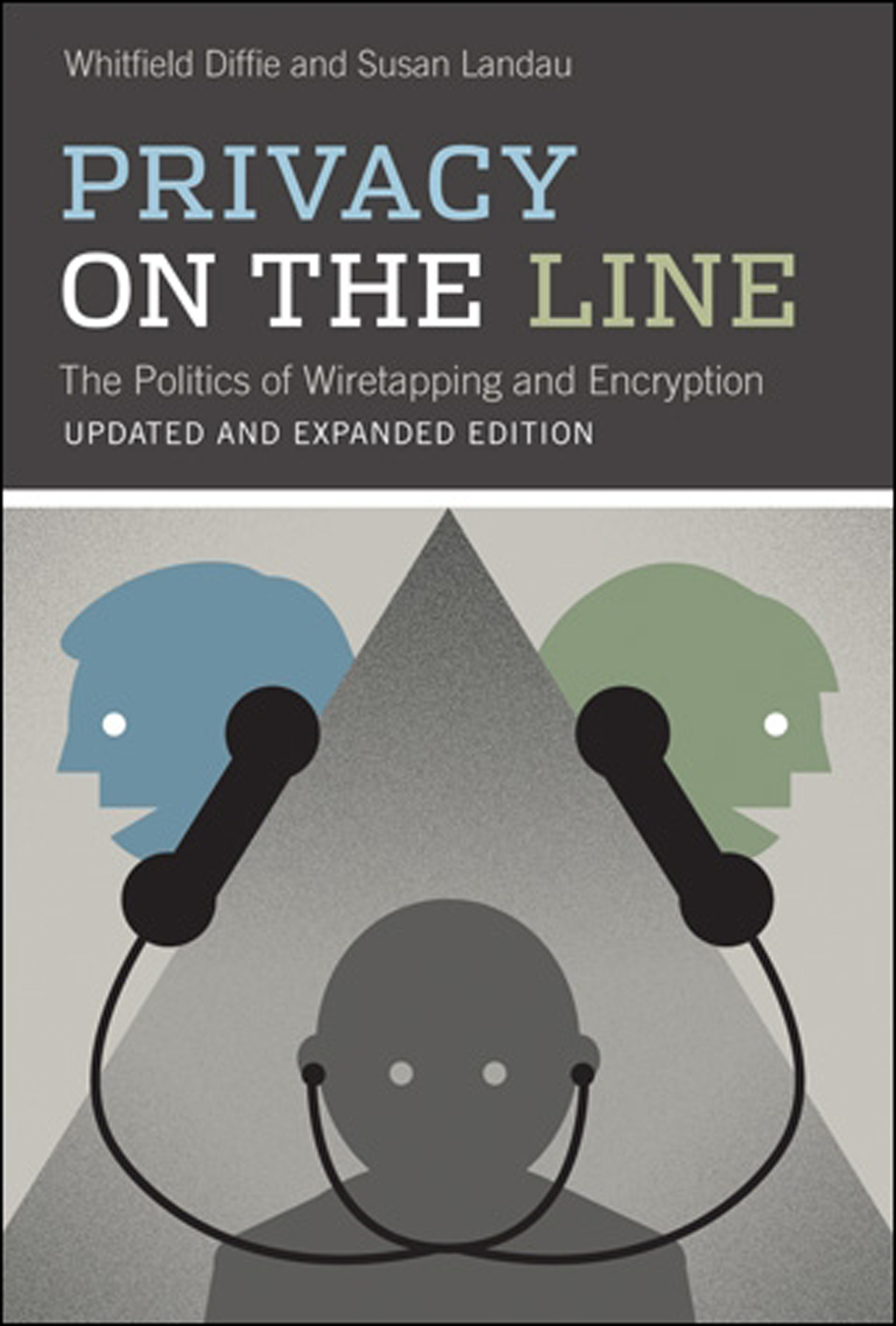
Privacy on the Line, updated and expanded edition A penetrating and insightful study of privacy and security in telecommunications for a post-9/11, post-Patriot Act world. Telecommunication has never been perfectly secure. The Cold War culture of recording devices in telephone receivers and bugged embassy offices has been succeeded by a post-9/11 world of NSA wiretaps and demands for data retention. Although the 1990s battle for individual and commercial freedom to use cryptography was won, growth in the use of cryptography has been slow. Meanwhile, regulations requiring that the computer and communication industries build spying into their systems for government convenience have increased rapidly. The application of the 1994 Communications Assistance for Law Enforcement Act has expanded beyond the intent of Congress to apply to voice over Internet Protocol (VoIP) and other modern data services; attempts are being made to require ISPs to retain their data for years in case the government wants it; and data mining techniques developed for commercial marketing applications are being applied to widespread surveillance of the population. In Privacy on the Line, Whitfield Diffie and Susan Landau strip away the hype surrounding the policy debate over privacy to examine the national security, law enforcement, commercial, and civil liberties issues. They discuss the social function of privacy, how it underlies a democratic society, and what happens when it is lost. This updated and expanded edition revises their original—and prescient—discussions of both policy and technology in light of recent controversies over NSA spying and other government threats to communications privacy. POLITICAL SCIENCE,Civil Rights

The Story of Cruel and Unusual A searing indictment of the American penal system that finds the roots of the recent prisoner abuse at Abu Ghraib and Guantánamo in the steady dismantling of the Eighth Amendment's prohibition of "cruel and unusual" punishment. The revelations of prisoner abuse and torture at Abu Ghraib and more recently at Guantánamo were shocking to most Americans. And those who condemned the treatment of prisoners abroad have focused on U.S. military procedures and abuses of executive powers in the war on terror, or, more specifically, on the now-famous White House legal counsel memos on the acceptable limits of torture. But in The Story of Cruel and Unusual, Colin Dayan argues that anyone who has followed U.S. Supreme Court decisions regarding the Eighth Amendment prohibition of "cruel and unusual" punishment would recognize the prisoners' treatment at Abu Ghraib and Guantánamo as a natural extension of the language of our courts and practices in U.S. prisons. In fact, it was no coincidence that White House legal counsel referred to a series of Supreme Court decisions in the 1980s and 1990s in making its case for torture.Dayan traces the roots of "acceptable" torture to slave codes of the nineteenth century that deeply embedded the dehumanization of the incarcerated in our legal system. Although the Eighth Amendment was interpreted generously during the prisoners' rights movement of the late 1960s and 1970s, this period of judicial concern was an anomaly. Over the last thirty years, Supreme Court decisions have once again dismantled Eighth Amendment protections and rendered such words as "cruel" and "inhuman" meaningless when applied to conditions of confinement and treatment during detention. Prisoners' actual pain and suffering have been explained away in a rhetorical haze—with rationalizations, for example, that measure cruelty not by the pain or suffering inflicted, but by the intent of the person who inflicted it. The Story of Cruel and Unusual is a stunningly original work of legal scholarship, and a searing indictment of the U.S. penal system. POLITICAL SCIENCE,Civil Rights
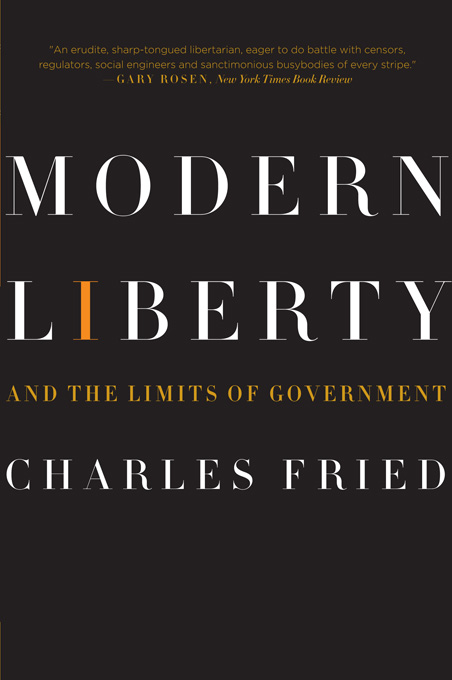
Modern Liberty “An erudite, sharp-tongued libertarian, eager to do battle with censors, regulators ... and sanctimonious busybodies of every stripe.â€â€”New York Times In this impassioned defense of liberty, renowned Harvard law professor Charles Fried argues that the seemingly unimpeachable goals of equality and community are often the most potent rivals of freedom. Declared a “spirited, sophisticated manifesto†by the New York Times Book Review, Modern Liberty demonstrates how the dense tangle of government regulations both supports and threatens our personal liberties. Armed with Fried’s insights, readers will be better able to defend themselves against those on both the left and the right who would, even with the best intentions, restrict their liberty. POLITICAL SCIENCE,Civil Rights
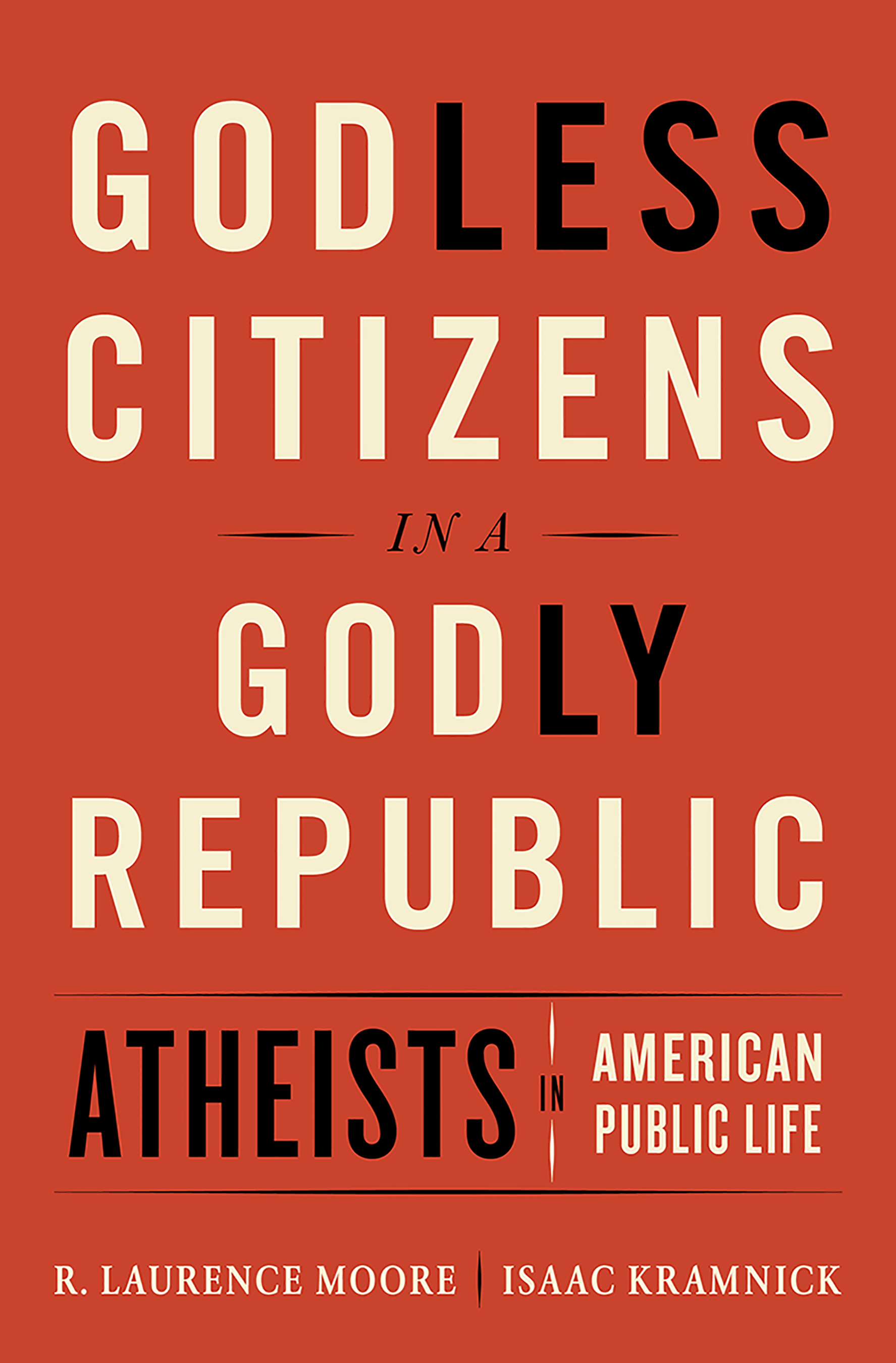
Godless Citizens in a Godly Republic “Illuminating.†—Phil Zuckerman, author of Living the Secular Life If the First Amendment protects the separation of church and state, why have atheists had to fight for their rights? In this valuable work, R. Laurence Moore and Isaac Kramnick reveal the fascinating history of atheism in America and the legal challenges to federal and state laws that made atheists second-class citizens. POLITICAL SCIENCE,Civil Rights

The End of the Second Reconstruction Democracy in the United States is under threat. The Trump administration’s attack on the legacy of the civil rights movement is undermining America’s claims to be a multi-racial democracy. This moment of peril has worrying parallels with a previous era of American history. The gains of the Reconstruction era after the civil war, which saw African Americans given full democratic rights, were totally reversed within a generation. There is a serious risk that the advances of the civil rights era – the ‘Second Reconstruction’ – will go the same way unless we learn from the past and appreciate that American democracy has never been a story of linear progress. Skilfully analysing the similarities – and the differences – between the 1870s and the 2010s, Johnson outlines a political strategy for avoiding a disastrous repetition of history in in the twilight of the Second Reconstruction. Anyone interested in seeing the Trump presidency in wider historical context, from students of race, politics and history in the US to the interested general reader, will find this book an essential and sobering guide to our past – and, if we’re not careful, our future. POLITICAL SCIENCE,Civil Rights
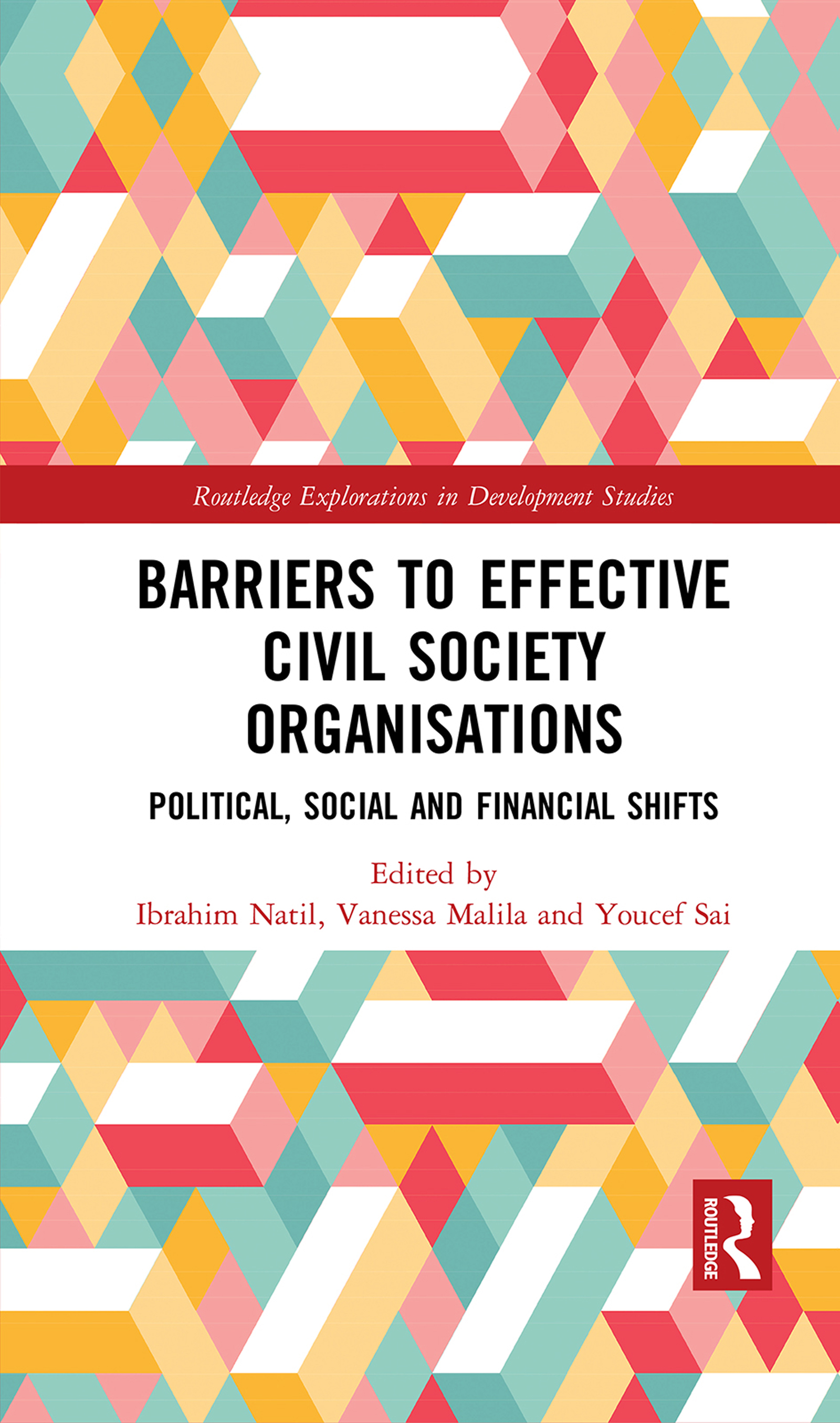
Barriers to Effective Civil Society Organisations This book provides an insight into the historical changes and present-day circumstances that have influenced, and continue to influence, the development and future of civil society. Civil society organisations (CSOs) play a crucial role in international development, however their impact on policy and practice is limited by a range of shifts across their political, social and financial landscapes. Barriers to Effective Civil Society Organisations is divided into three parts addressing each of these shifts in turn, and places particular emphasis on civil society actors linked not only by political constraints, but also by ethnic and cultural diversities that are crucial markers of political and social identity. This book draws on case studies from across Latin America, Africa, MENA and Ireland to highlight how CSOs in these countries are shaped by, and react to, shifting challenges. Reflecting on solutions for the sector, the authors provide an understanding of the various ‘self-accommodation’ policies and techniques employed by CSOs in order to continue their services and increase their credibility across global contexts. Aimed at researchers, policy makers and CSO/NGO workers looking to better understand the current state and future of the sector from the perspective of emerging scholars working in these regions, and in the Global South in particular, this innovative book is a celebration of the important work of CSOs and a reaffirmation of their right to sit at the policy table. POLITICAL SCIENCE,Civil Rights

The Diplomacy of Theodore Brown and the Nigeria-Biafra Civil War This book chronicles the diplomacy of civil rights activist Theodore Brown and the American Negro Leadership Conference on Africa to help end the Nigeria-Biafra civil war, from 1967 to 1970. POLITICAL SCIENCE,Civil Rights

Cómo ser antirracista “EL MEJOR LIBRO DEL AÑO” The New York Times Book Review • Time • NPR • The Washington Post • Shelf Awareness • Library Journal • Publishers Weekly • Kirkus Reviews El racismo es, en su esencia, un sistema poderoso que crea falsas jerarquías de los valores humanos; su lógica distorsionada se extiende más allá de la raza: desde la forma en que consideramos a las personas de diferentes etnias o colores de piel hasta el modo en que tratamos a las personas de diferentes sexos, identidades de género y tipos de cuerpo. El racismo se entrecruza con asuntos de clase, cultura y geografía e incluso cambia la manera en que nos vemos y nos valoramos. En Cómo ser antirracista, Kendi lleva a los lectores a través de un círculo cada vez más amplio de ideas antirracistas —desde los conceptos más básicos hasta sus posibilidades visionarias— que ayudarán a identificar claramente todas las formas de racismo, comprender sus peligrosas consecuencias y trabajar para oponerse a ellas tanto en nuestros sistemas sociales como en nuestro interior.El antirracismo es un concepto transformador que reorienta y revitaliza la conversación sobre el racismo y, más fundamentalmente, nos señala nuevas formas de pensar sobre nosotros mismos y los que nos rodean. Kendi teje una combinación electrizante de ética, historia, derecho y ciencia con su propia historia personal de despertar al antirracismo. Una obra esencial para quien desee ir más allá de la simple conciencia del racismo y dar un paso más allá para contribuir a la formación de una sociedad justa y equitativa. POLITICAL SCIENCE,Civil Rights
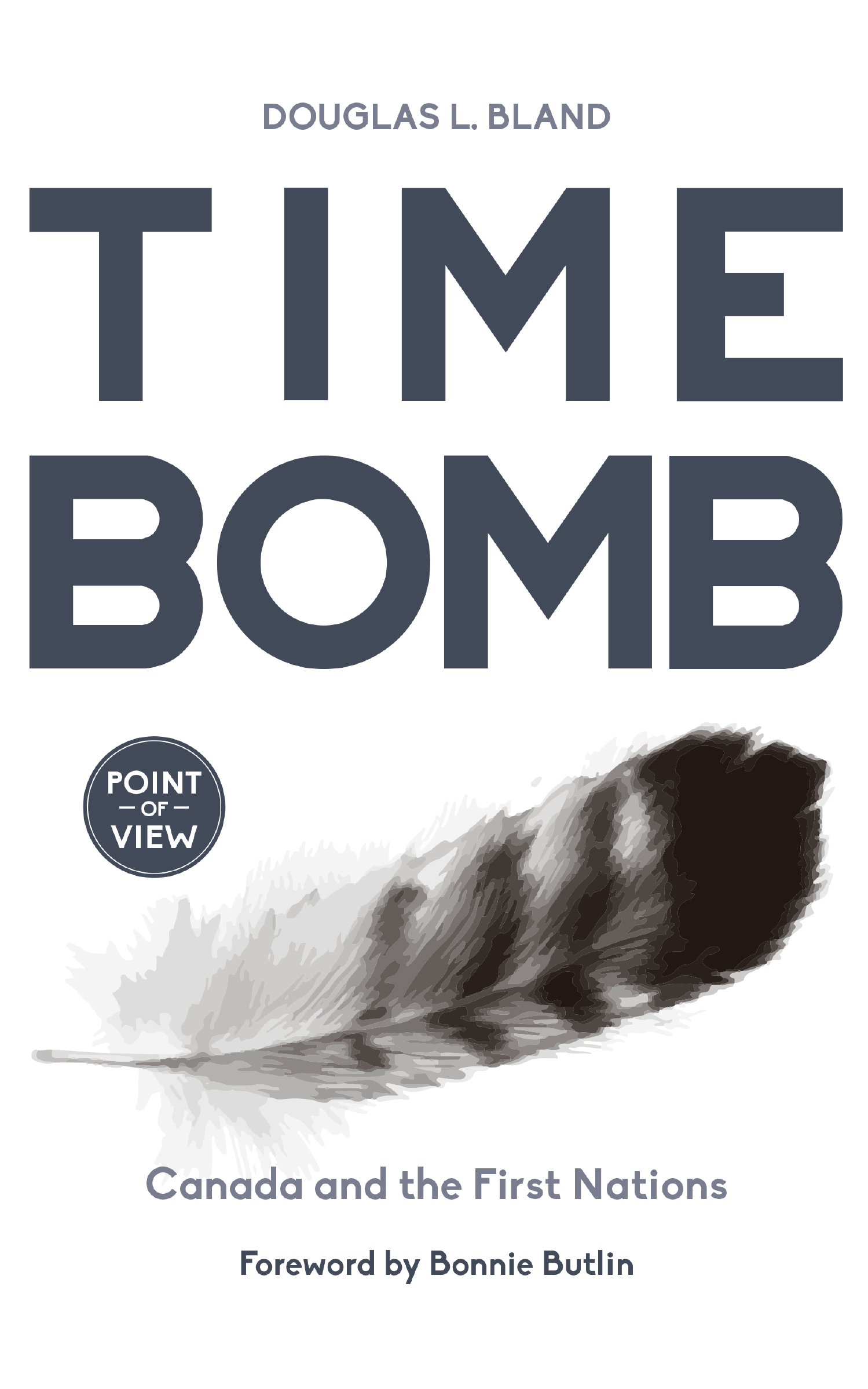
Time Bomb A catastrophic confrontation between Canada's so-called "settlers" and First Nations communities, fuelled by fundamental prejudices, misunderstandings, Canada's economic vulnerabilities, and the rising political power within the First Nations society, make such a First Nations uprising feasible and, in theory, inevitable. POLITICAL SCIENCE,Colonialism & Post-Colonialism
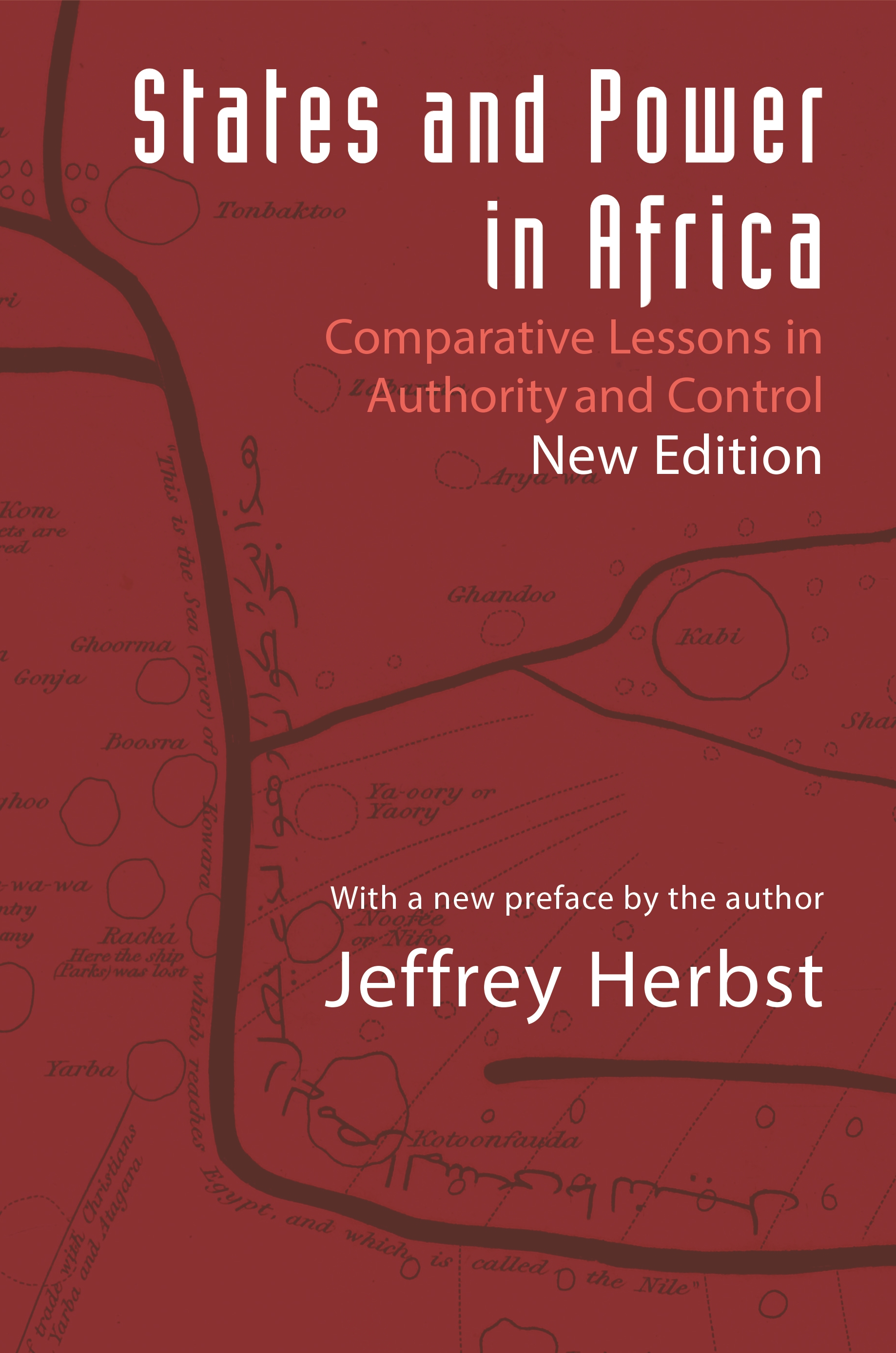
States and Power in Africa Theories of international relations, assumed to be universally applicable, have failed to explain the creation of states in Africa. There, the interaction of power and space is dramatically different from what occurred in Europe. In States and Power in Africa, Jeffrey Herbst places the African state-building process in a truly comparative perspective. Herbst's bold contention—that the conditions now facing African state-builders existed long before European penetration of the continent—is sure to provoke controversy, for it runs counter to the prevailing assumption that colonialism changed everything. This revised edition includes a new preface in which the author links the enormous changes that have taken place in Africa over the past fifteen years to long-term state consolidation. The final chapter on policy prescriptions has also been revised to reflect the evolution of African and international responses to state failure. POLITICAL SCIENCE,Colonialism & Post-Colonialism

The Colonial Origins of Ethnic Violence in India The neighboring north Indian districts of Jaipur and Ajmer are identical in language, geography, and religious and caste demography. But when the famous Babri Mosque in Ayodhya was destroyed in 1992, Jaipur burned while Ajmer remained peaceful; when the state clashed over low-caste affirmative action quotas in 2008, Ajmer's residents rioted while Jaipur's citizens stayed calm. What explains these divergent patterns of ethnic conflict across multiethnic states? Using archival research and elite interviews in five case studies spanning north, south, and east India, as well as a quantitative analysis of 589 districts, Ajay Verghese shows that the legacies of British colonialism drive contemporary conflict. Because India served as a model for British colonial expansion into parts of Africa and Southeast Asia, this project links Indian ethnic conflict to violent outcomes across an array of multiethnic states, including cases as diverse as Nigeria and Malaysia. The Colonial Origins of Ethnic Violence in India makes important contributions to the study of Indian politics, ethnicity, conflict, and historical legacies. POLITICAL SCIENCE,Colonialism & Post-Colonialism

War Against All Puerto Ricans The powerful, untold story of the 1950 revolution in Puerto Rico and the long history of U.S. intervention on the island, that the New York Times says "could not be more timely." In 1950, after over fifty years of military occupation and colonial rule, the Nationalist Party of Puerto Rico staged an unsuccessful armed insurrection against the United States. Violence swept through the island: assassins were sent to kill President Harry Truman, gunfights roared in eight towns, police stations and post offices were burned down. In order to suppress this uprising, the US Army deployed thousands of troops and bombarded two towns, marking the first time in history that the US government bombed its own citizens. Nelson A. Denis tells this powerful story through the controversial life of Pedro Albizu Campos, who served as the president of the Nationalist Party. A lawyer, chemical engineer, and the first Puerto Rican to graduate from Harvard Law School, Albizu Campos was imprisoned for twenty-five years and died under mysterious circumstances. By tracing his life and death, Denis shows how the journey of Albizu Campos is part of a larger story of Puerto Rico and US colonialism. Through oral histories, personal interviews, eyewitness accounts, congressional testimony, and recently declassified FBI files, War Against All Puerto Ricans tells the story of a forgotten revolution and its context in Puerto Rico's history, from the US invasion in 1898 to the modern-day struggle for self-determination. Denis provides an unflinching account of the gunfights, prison riots, political intrigue, FBI and CIA covert activity, and mass hysteria that accompanied this tumultuous period in Puerto Rican history. POLITICAL SCIENCE,Colonialism & Post-Colonialism

Asylum after Empire This book critiques existing literature on the response of Western states to asylum seeking ‘others’ and outlines an alternative perspective to acknowledge the colonial histories that have shaped the contemporary response of states to movements of refugees. POLITICAL SCIENCE,Colonialism & Post-Colonialism

Inglorious Empire Inglorious Empire tells the real story of the British in India — from the arrival of the East India Company to the end of the Raj — and reveals how Britain’s rise was built upon its plunder of India. In the eighteenth century, India’s share of the world economy was as large as Europe’s. By 1947, after two centuries of British rule, it had decreased six-fold. Beyond conquest and deception, the Empire blew rebels from cannon, massacred unarmed protesters, entrenched institutionalised racism, and caused millions to die from starvation. British imperialism justified itself as enlightened despotism for the benefit of the governed, but Shashi Tharoor takes on and demolishes this position, demonstrating how every supposed imperial ‘gift’ — from the railways to the rule of law — was designed in Britain’s interests alone. He goes on to show how Britain’s Industrial Revolution was founded on India’s deindustrialisation, and the destruction of its textile industry. In this bold and incisive reassessment of colonialism, Tharoor exposes to devastating effect the inglorious reality of Britain’s stained Indian legacy. POLITICAL SCIENCE,Colonialism & Post-Colonialism
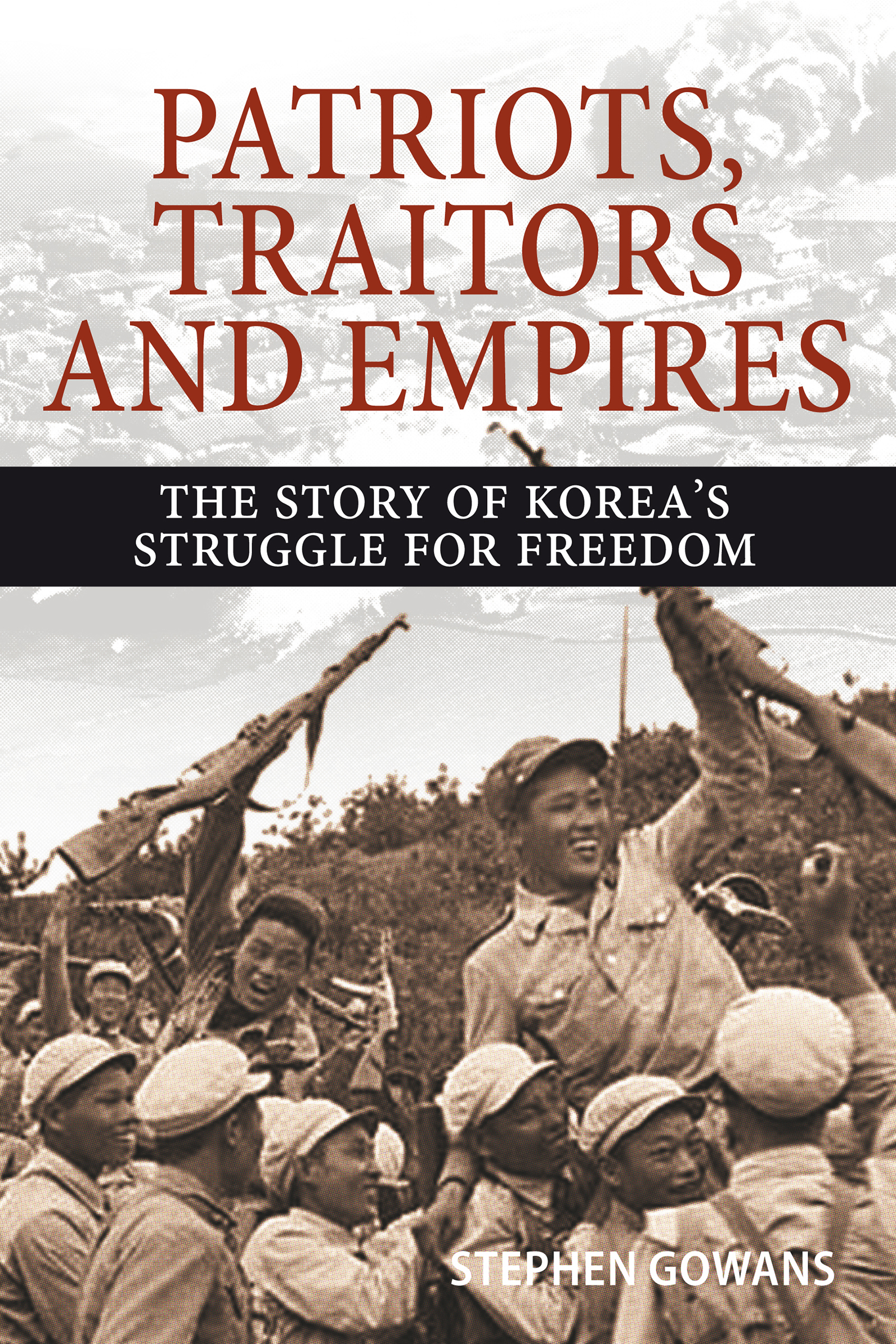
Patriots, Traitors and Empires Patriots, Traitors and Empires is an account of modern Korean history, written from the point of view of those who fought to free their country from the domination of foreign empires. It traces the history of Korea's struggle for freedom from opposition to Japanese colonialism starting in 1905 to North Korea's current efforts to deter the threat of invasion by the United States or anybody else by having nuclear weapons. Koreans have been fighting a civil war since 1932, when Kim Il Sung, founder of the Democratic People's Republic of Korea, along with other Korean patriots, launched a guerrilla war against Japanese colonial domination. Other Koreans, traitors to the cause of Korea's freedom, including a future South Korean president, joined the side of Japan's Empire, becoming officers in the Japanese army or enlisting in the hated colonial police force. From early in the 20th century when Japan incorporated Korea into its burgeoning empire, Koreans have struggled against foreign domination, first by Japan then by the United States. Patriots, Traitors and Empires, The Story of Korea's Struggle for Freedom is a much-needed antidote to the jingoist clamor spewing from all quarters whenever Korea is discussed. POLITICAL SCIENCE,Colonialism & Post-Colonialism

Undoing Border Imperialism Cutting-edge practice and theory from the front lines of the movements for indigenous and transnational freedom. POLITICAL SCIENCE,Colonialism & Post-Colonialism

Empire, Global Coloniality and African Subjectivity Global imperial designs, which have been in place since conquest by western powers, did not suddenly evaporate after decolonization. Global coloniality as a leitmotif of the empire became the order of the day, with its invisible technologies of subjugation continuing to reproduce Africa’s subaltern position, a position characterized by perceived deficits ranging from a lack of civilization, a lack of writing and a lack of history to a lack of development, a lack of human rights and a lack of democracy. The author’s sharply critical perspective reveals how this epistemology of alterity has kept Africa ensnared within colonial matrices of power, serving to justify external interventions in African affairs, including the interference with liberation struggles and disregard for African positions. Evaluating the quality of African responses and available options, the author opens up a new horizon that includes cognitive justice and new humanism. POLITICAL SCIENCE,Colonialism & Post-Colonialism

Navigating Colonial Orders Norwegians in colonial Africa and Oceania had varying aspirations and adapted in different ways to changing social, political and geographical circumstances in foreign, colonial settings. They included Norwegian shipowners, captains, and diplomats; traders and whalers along the African coast and in Antarctica; large-scale plantation owners in Mozambique and Hawai’i; big business men in South Africa; jacks of all trades in the Solomon Islands; timber merchants on Zanzibar’ coffee farmers in Kenya; and King Leopold’s footmen in Congo. This collection reveals narratives of the colonial era that are often ignored or obscured by the national histories of former colonial powers. It charts the entrepreneurial routes chosen by various Norwegians and the places they ventured, while demonstrating the importance of recognizing the complicity of such “non-colonial colonials†for understanding the complexity of colonial history. POLITICAL SCIENCE,Colonialism & Post-Colonialism

Sex and Control In responding to the perceived threat posed by venereal diseases in Germany’s colonies, doctors took a biopolitical approach that employed medical and bourgeois discourses of modernization, health, productivity, and morality. Their goal was to change the behavior of targeted groups, or at least to isolate infected individuals from the healthy population. However, the Africans, Pacific Islanders, and Asians they administered to were not passive recipients of these strategies. Rather, their behavior strongly influenced the efficacy and nature of these public health measures. While an apparent degree of compliance was achieved, over time physicians increasingly relied on disciplinary measures beyond what was possible in Germany in order to enforce their policies. Ultimately, through their discourses and actions they contributed to the justification for and the maintenance of German colonialism. POLITICAL SCIENCE,Colonialism & Post-Colonialism

An Earth-colored Sea Although the post-colonial situation has attracted considerable interest over recent years, one important colonial power – Portugal – has not been given any attention. This book is the first to explore notions of ethnicity, "race", culture, and nation in the context of the debate on colonialism and postcolonialism. The structure of the book reflects a trajectory of research, starting with a case study in Trinidad, followed by another one in Brazil, and ending with yet another one in Portugal. The three case studies, written in the ethnographic genre, are intertwined with essays of a more theoretical nature. The non-monographic, composite – or hybrid – nature of this work may be in itself an indication of the need for transnational and historically grounded research when dealing with issues of representations of identity that were constructed during colonial times and that are today reconfigured in the ideological struggles over cultural meanings. POLITICAL SCIENCE,Colonialism & Post-Colonialism

Picturing Pity Picturing Pity is the first full length monograph on missionary photography. Empirically, it is based on an in-depth analysis of the published photographs taken by Norwegian evangelical missionaries in Northern Cameroon from the early nineteen twenties, at the beginning of their activities in this region, and until today. Being part of a large international movement, Norway sent out more missionaries per capita than any other country in Europe. Marianne Gullestad's main contention is that the need to continuously justify their activities to donors in Europe has led to the creation and maintenance of specific ways of portraying Africans. The missionary visual rhetoric is both based on earlier visualizations and has over time established its own conventions which can now also be traced within secular fields of activity such as international development agencies, foreign policy, human relief organizations and the mass media. Picturing Pity takes part in the present "pictorial turn" in academic teaching and research, constituting visual images as an exciting site of conversation across disciplinary lines. POLITICAL SCIENCE,Colonialism & Post-Colonialism
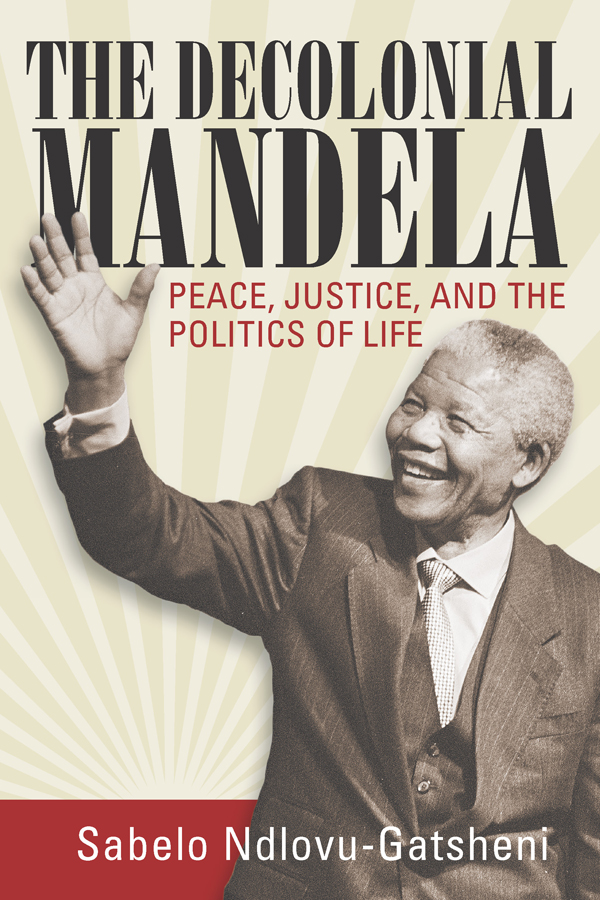
The Decolonial Mandela A significant contribution to the emerging literature on decolonial studies, this concise and forcefully argued volume lays out a groundbreaking interpretation of the “Mandela phenomenon.†Contrary to a neoliberal social model that privileges adversarial criminal justice and a rationalistic approach to war making, Sabelo J. Ndlovu-Gatsheni identifies transformative political justice and a reimagined social order as key features of Nelson Mandela’s legacy. Mandela is understood here as an exemplar of decolonial humanism, one who embodied the idea of survivor’s justice and held up reconciliation and racial harmony as essential for transcending colonial modes of thought. POLITICAL SCIENCE,Colonialism & Post-Colonialism
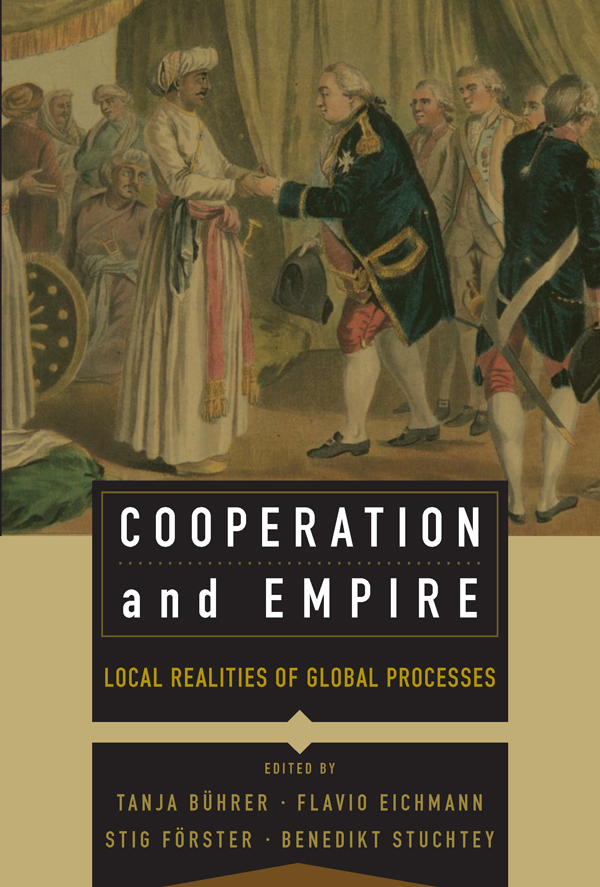
Cooperation and Empire While the study of “indigenous intermediaries†is today the focus of some of the most interesting research in the historiography of colonialism, its roots extend back to at least the 1970s. The contributions to this volume revisit Ronald E. Robinson’s theory of collaboration in a range of historical contexts by melding it with theoretical perspectives derived from postcolonial studies and transnational history. In case studies ranging globally over the course of four centuries, these essays offer nuanced explorations of the varied, complex interactions between imperial and local actors, with particular attention to those shifting and ambivalent roles that transcend simple binaries of colonizer and colonized. POLITICAL SCIENCE,Colonialism & Post-Colonialism
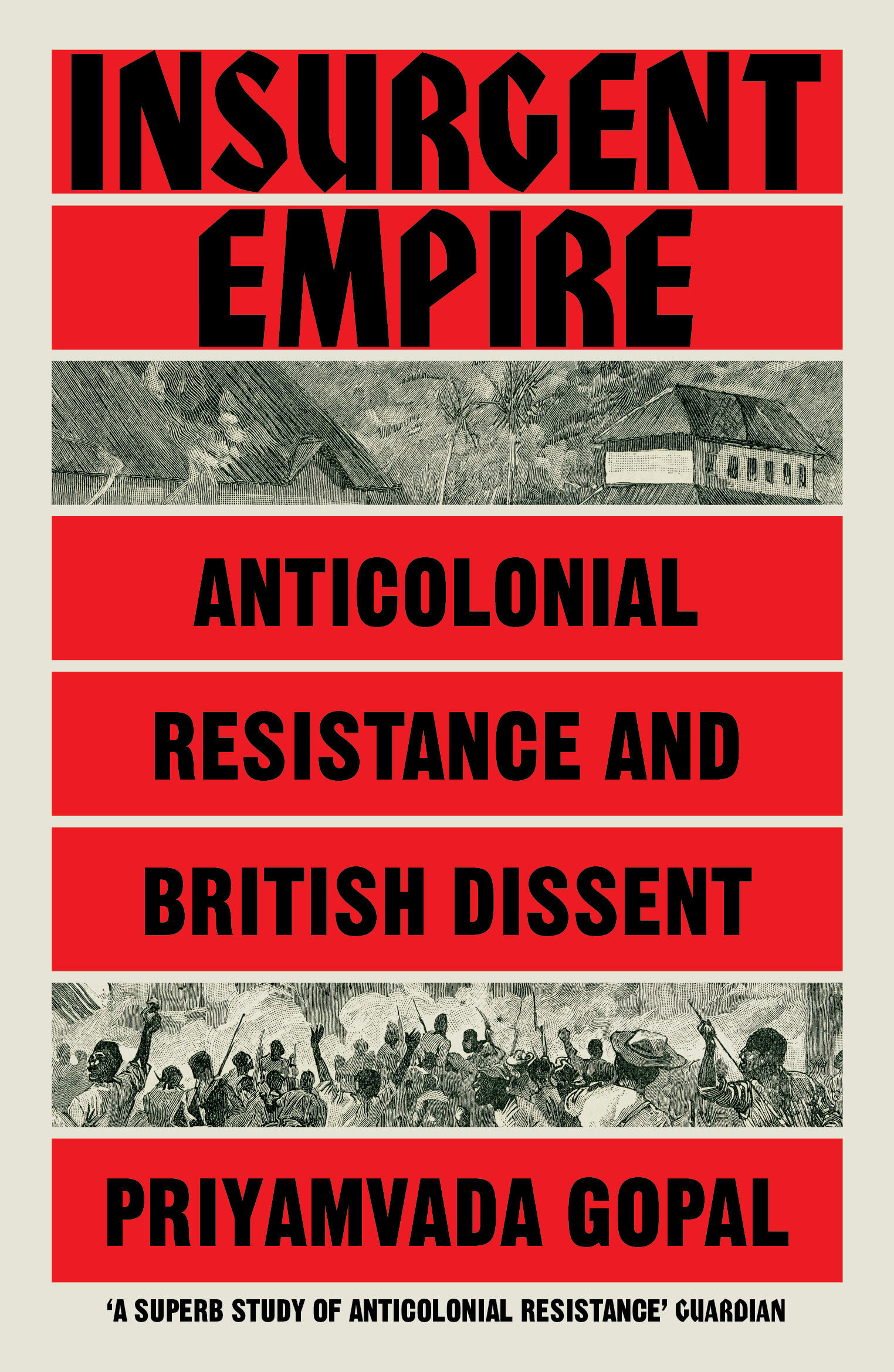
Insurgent Empire How rebellious colonies changed British attitudes to empire Insurgent Empire shows how Britain’s enslaved and colonial subjects were active agents in their own liberation. What is more, they shaped British ideas of freedom and emancipation back in the United Kingdom. Priyamvada Gopal examines a century of dissent on the question of empire and shows how British critics of empire were influenced by rebellions and resistance in the colonies, from the West Indies and East Africa to Egypt and India. In addition, a pivotal role in fomenting resistance was played by anticolonial campaigners based in London, right at the heart of empire. Much has been written on how colonized peoples took up British and European ideas and turned them against empire when making claims to freedom and self-determination. Insurgent Empire sets the record straight in demonstrating that these people were much more than victims of imperialism or, subsequently, the passive beneficiaries of an enlightened British conscience—they were insurgents whose legacies shaped and benefited the nation that once oppressed them. POLITICAL SCIENCE,Colonialism & Post-Colonialism

The Freedoms We Lost A brilliant and original examination of American freedom as it existed before the Revolution, from the Smithsonian’s curator of social history. The American Revolution is widely understood—by schoolchildren and citizens alike—as having ushered in “freedom†as we know it, a freedom that places voting at the center of American democracy. In a sharp break from this view, historian Barbara Clark Smith charts the largely unknown territory of the unique freedoms enjoyed by colonial American subjects of the British king—that is, American freedom before the Revolution. The Freedoms We Lost recovers a world of common people regularly serving on juries, joining crowds that enforced (or opposed) the king’s edicts, and supplying community enforcement of laws in an era when there were no professional police. The Freedoms We Lost challenges the unquestioned assumption that the American patriots simply introduced freedom where the king had once reigned. Rather, Smith shows that they relied on colonial-era traditions of political participation to drive the Revolution forward—and eventually, betrayed these same traditions as leading patriots gravitated toward “monied men†and elites who would limit the role of common men in the new democracy. By the end of the 1780s, she shows, Americans discovered that forms of participation once proper to subjects of Britain were inappropriate—even impermissible—to citizens of the United States. In a narrative that counters nearly every textbook account of America’s founding era, The Freedoms We Lost challenges us to think about what it means to be free. POLITICAL SCIENCE,Colonialism & Post-Colonialism
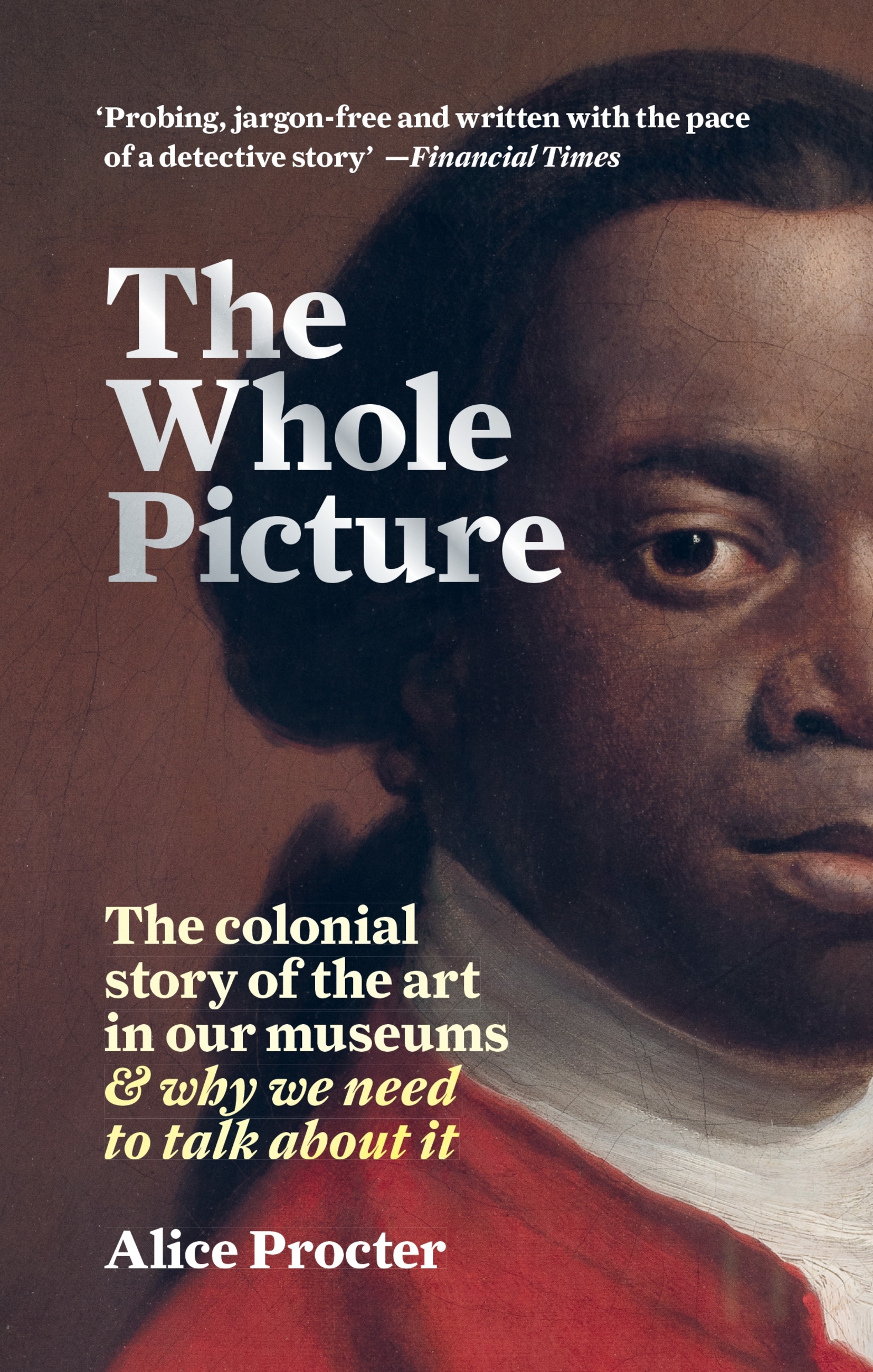
The Whole Picture "Probing, jargon-free and written with the pace of a detective story... [Procter] dissects western museum culture with such forensic fury that it might be difficult for the reader ever to view those institutions in the same way again. " Financial Times 'A smart, accessible and brilliantly structured work that encourages readers to go beyond the grand architecture of cultural institutions and see the problematic colonial histories behind them.' - Sumaya Kassim Should museums be made to give back their marbles? Is it even possible to 'decolonize' our galleries? Must Rhodes fall? How to deal with the colonial history of art in museums and monuments in the public realm is a thorny issue that we are only just beginning to address. Alice Procter, creator of the Uncomfortable Art Tours, provides a manual for deconstructing everything you thought you knew about art history and tells the stories that have been left out of the canon. The book is divided into four chronological sections, named after four different kinds of art space: The Palace, The Classroom, The Memorial and The Playground. Each section tackles the fascinating, enlightening and often shocking stories of a selection of art pieces, including the propaganda painting the East India Company used to justify its rule in India; the tattooed Maori skulls collected as 'art objects' by Europeans; and works by contemporary artists who are taking on colonial history in their work and activism today. The Whole Picture is a much-needed provocation to look more critically at the accepted narratives about art, and rethink and disrupt the way we interact with the museums and galleries that display it. POLITICAL SCIENCE,Colonialism & Post-Colonialism

Civilizational Imperatives In Civilizational Imperatives, Oliver Charbonneau reveals the little-known history of the United States' colonization of the Philippines' Muslim South in the early twentieth century. Often referred to as Moroland, the Sulu Archipelago and the island of Mindanao were sites of intense US engagement and laboratories of colonial modernity during an age of global imperialism. Exploring the complex relationship between colonizer and colonized from the late nineteenth century until the eve of the Second World War, Charbonneau argues that American power in the Islamic Philippines rested upon a transformative vision of colonial rule. Civilization, protection, and instruction became watchwords for US military officers and civilian administrators, who enacted fantasies of racial reform among the diverse societies of the region. Violence saturated their efforts to remake indigenous politics and culture, embedding itself into governance strategies used across four decades. Although it took place on the edges of the Philippine colonial state, this fraught civilizing mission did not occur in isolation. It shared structural and ideological connections to US settler conquest in North America and also borrowed liberally from European and Islamic empires. These circuits of cultural, political, and institutional exchange—accessed by colonial and anticolonial actors alike—gave empire in the Southern Philippines its hybrid character. Civilizational Imperatives is a story of colonization and connection, reaching across nations and empires in its examination of a Southeast Asian space under US sovereignty. It presents an innovative new portrait of the American empire's global dimensions and the many ways they shaped the colonial encounter in the Southern Philippines. POLITICAL SCIENCE,Colonialism & Post-Colonialism
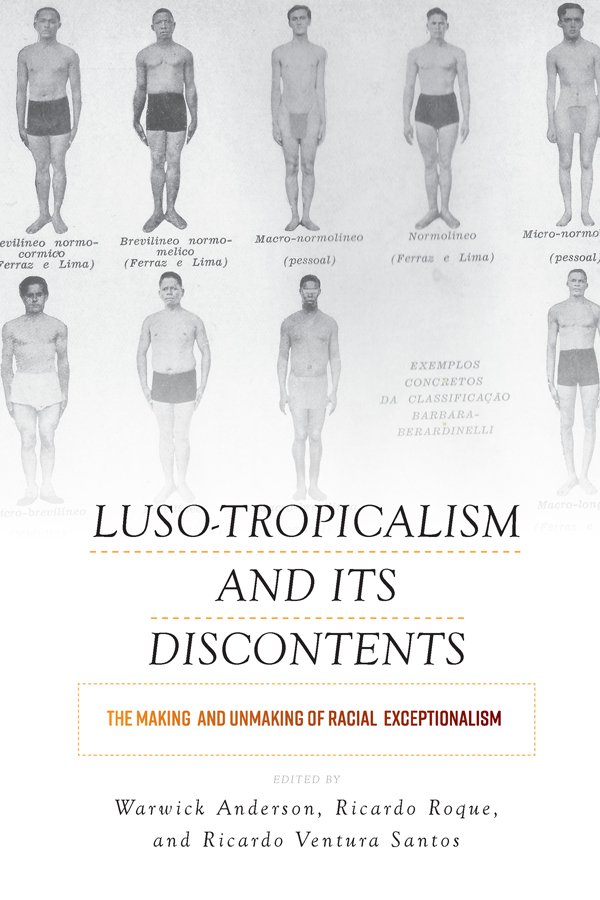
Luso-Tropicalism and Its Discontents Modern perceptions of race across much of the Global South are indebted to the Brazilian social scientist Gilberto Freyre, who in works such as The Masters and the Slaves claimed that Portuguese colonialism produced exceptionally benign and tolerant race relations. This volume radically reinterprets Freyre’s Luso-tropicalist arguments and critically engages with the historical complexity of racial concepts and practices in the Portuguese-speaking world. Encompassing Brazil as well as Portuguese-speaking societies in Africa, Asia, and even Portugal itself, it places an interdisciplinary group of scholars in conversation to challenge the conventional understanding of twentieth-century racialization, proffering new insights into such controversial topics as human plasticity, racial amalgamation, and the tropes and proxies of whiteness. POLITICAL SCIENCE,Colonialism & Post-Colonialism
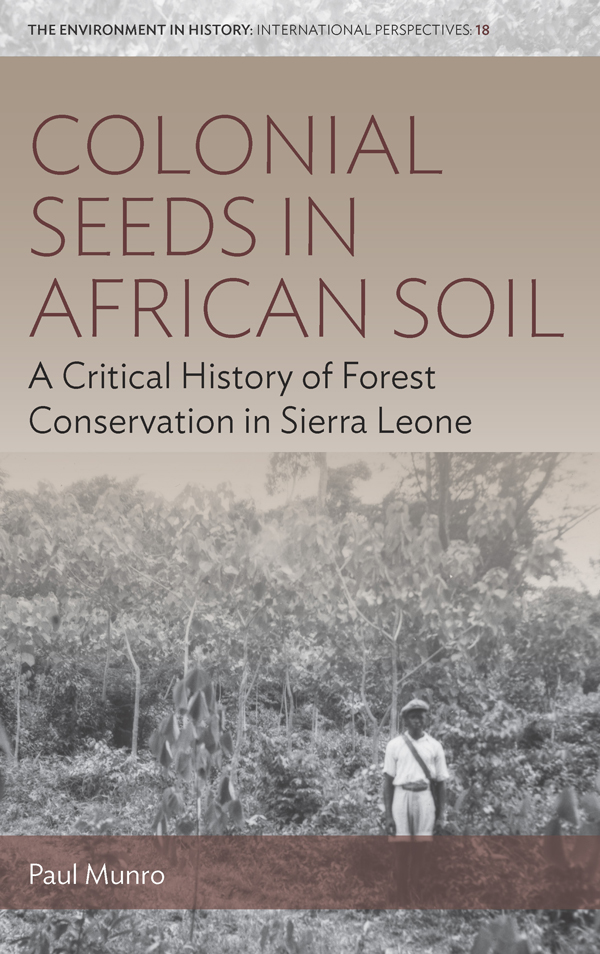
Colonial Seeds in African Soil “Empire forestryâ€â€”the broadly shared forest management practice that emerged in the West in the nineteenth century—may have originated in Europe, but it would eventually reshape the landscapes of colonies around the world. Melding the approaches of environmental history and political ecology, Colonial Seeds in African Soil unravels the complex ways this dynamic played out in twentieth-century colonial Sierra Leone. While giving careful attention to topics such as forest reservation and exploitation, the volume moves beyond conservation practices and discourses, attending to the overlapping social, economic, and political contexts that have shaped approaches to forest management over time. POLITICAL SCIENCE,Colonialism & Post-Colonialism
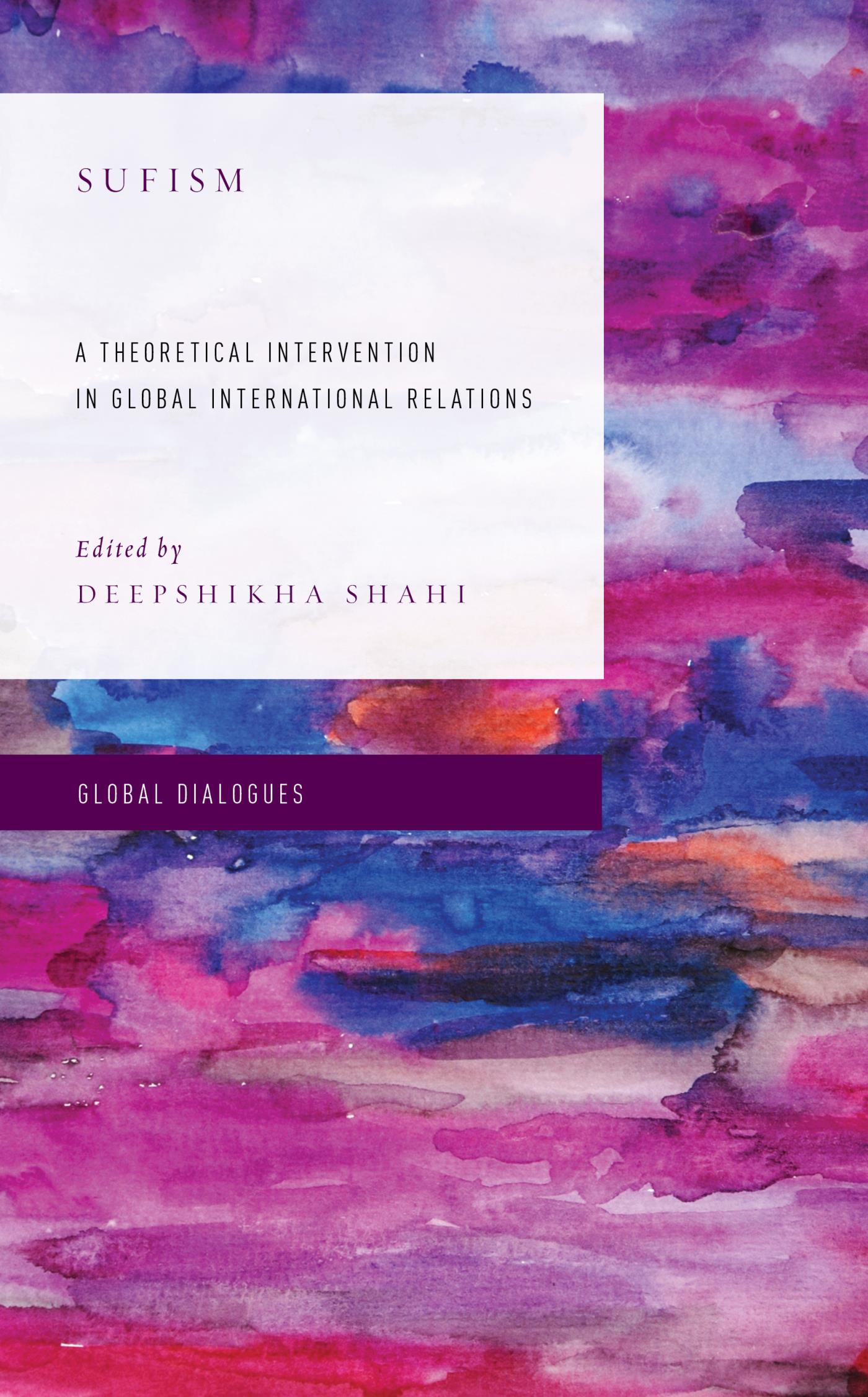
Sufism This book explores how ‘Sufism’ – as an established non-Western philosophy with a remarkable temporal-spatial spread across the globe – facilitates a creative intervention in the theoretical-practical understanding of Global IR. POLITICAL SCIENCE,Colonialism & Post-Colonialism
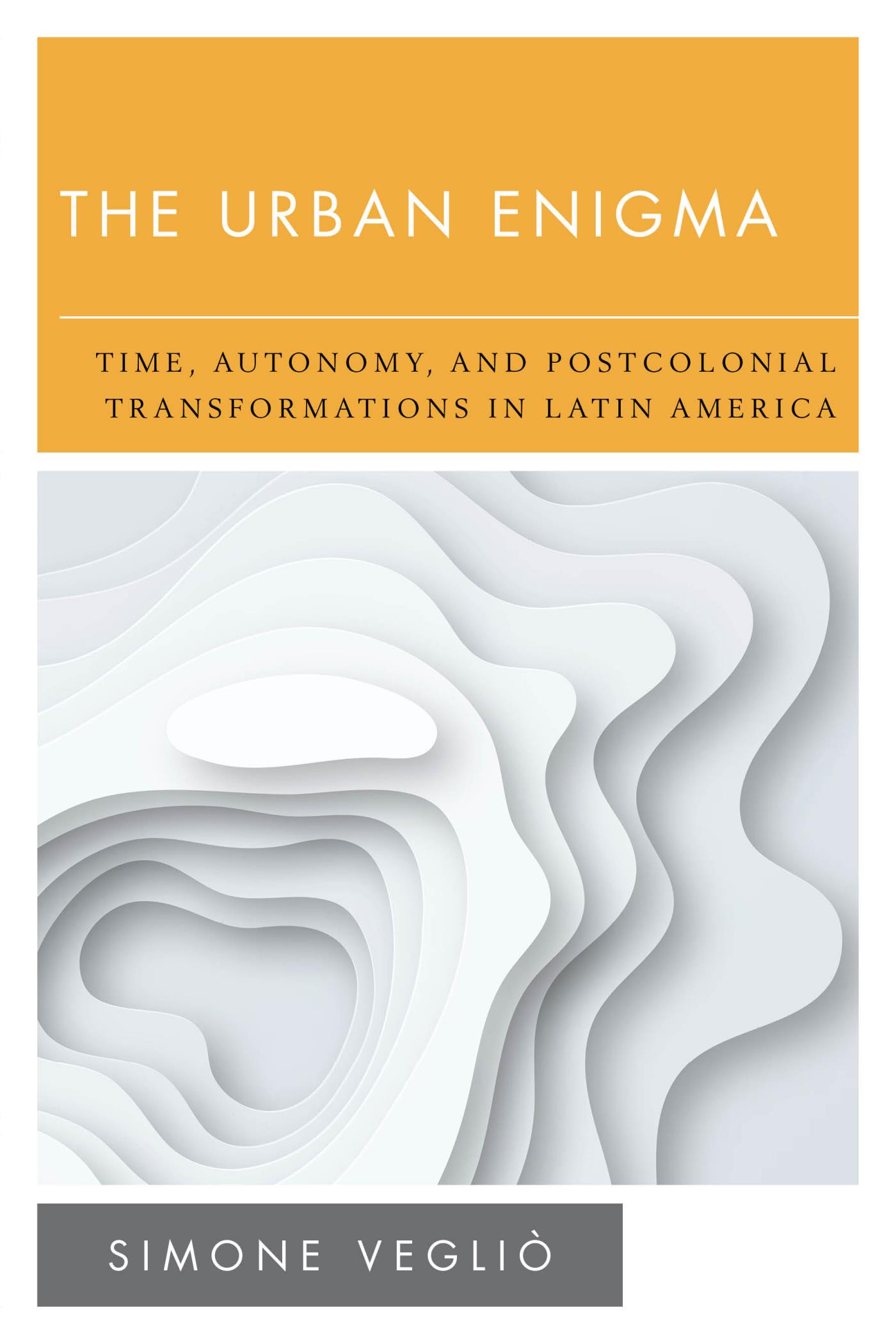
The Urban Enigma The book shows how the question of time was crucial for the specific articulation of Latin America’s postcolonialism. POLITICAL SCIENCE,Colonialism & Post-Colonialism
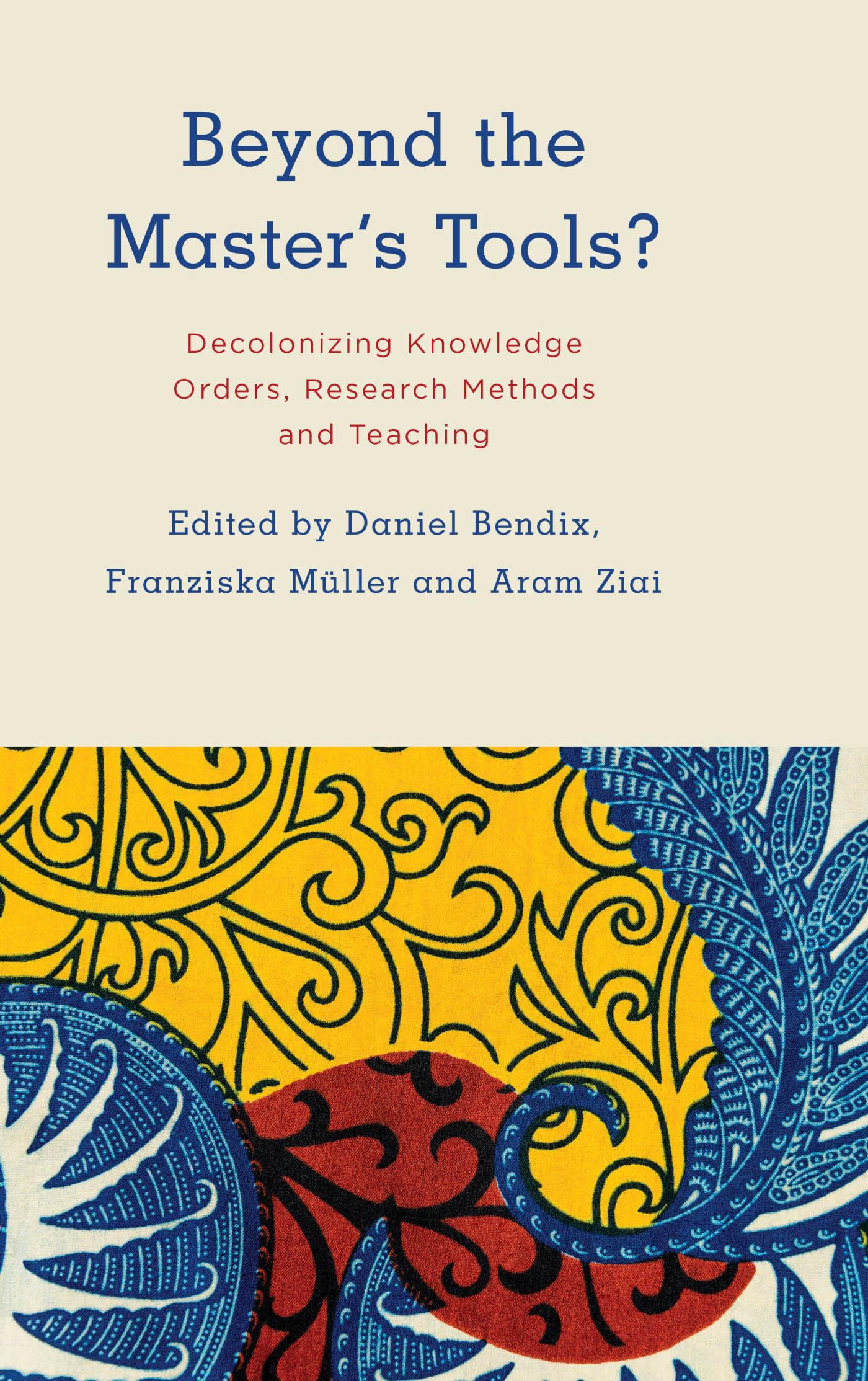
Beyond the Master's Tools? Offers strategies for decolonizing research methods in the social sciences based on both methodological considerations and broad empirical experience POLITICAL SCIENCE,Colonialism & Post-Colonialism
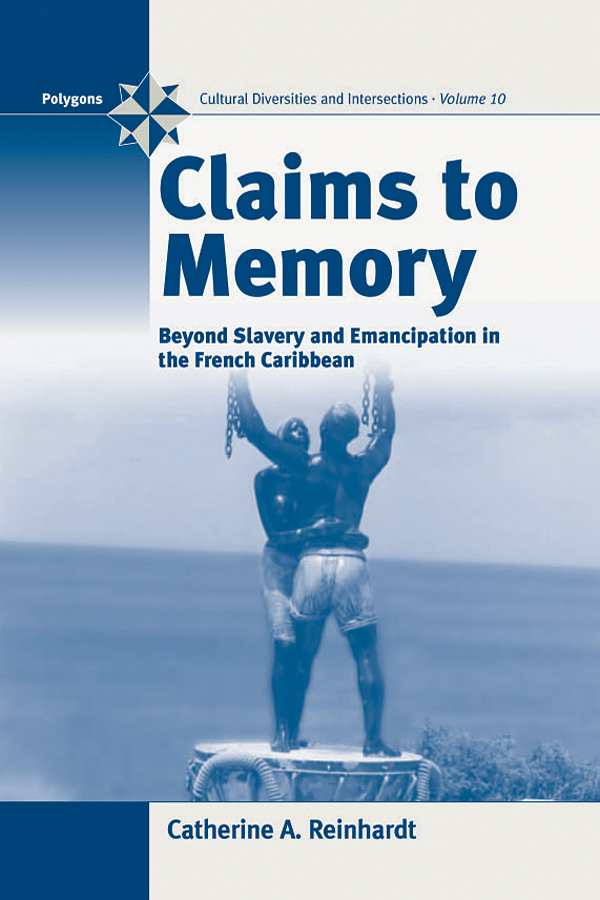
Claims to Memory Why do the people of the French Caribbean still continue to be haunted by the memory of their slave past more than one hundred and fifty years after the abolition of slavery? What process led to the divorce of their collective memory of slavery and emancipation from France's portrayal of these historical phenomena? How are Martinicans and Guadeloupeans today transforming the silences of the past into historical and cultural manifestations rooted in the Caribbean? This book answers these questions by relating the 1998 controversy surrounding the 150th anniversary of France's abolition of slavery to the period of the slave regime spanning the late Enlightenment and the French Revolution. By comparing a diversity of documents—including letters by slaves, free people of color, and planters, as well as writings by the philosophes, royal decrees, and court cases—the author untangles the complex forces of the slave regime that have shaped collective memory. The current nationalization of the memory of slavery in France has turned these once peripheral claims into passionate political and cultural debates. POLITICAL SCIENCE,Colonialism & Post-Colonialism
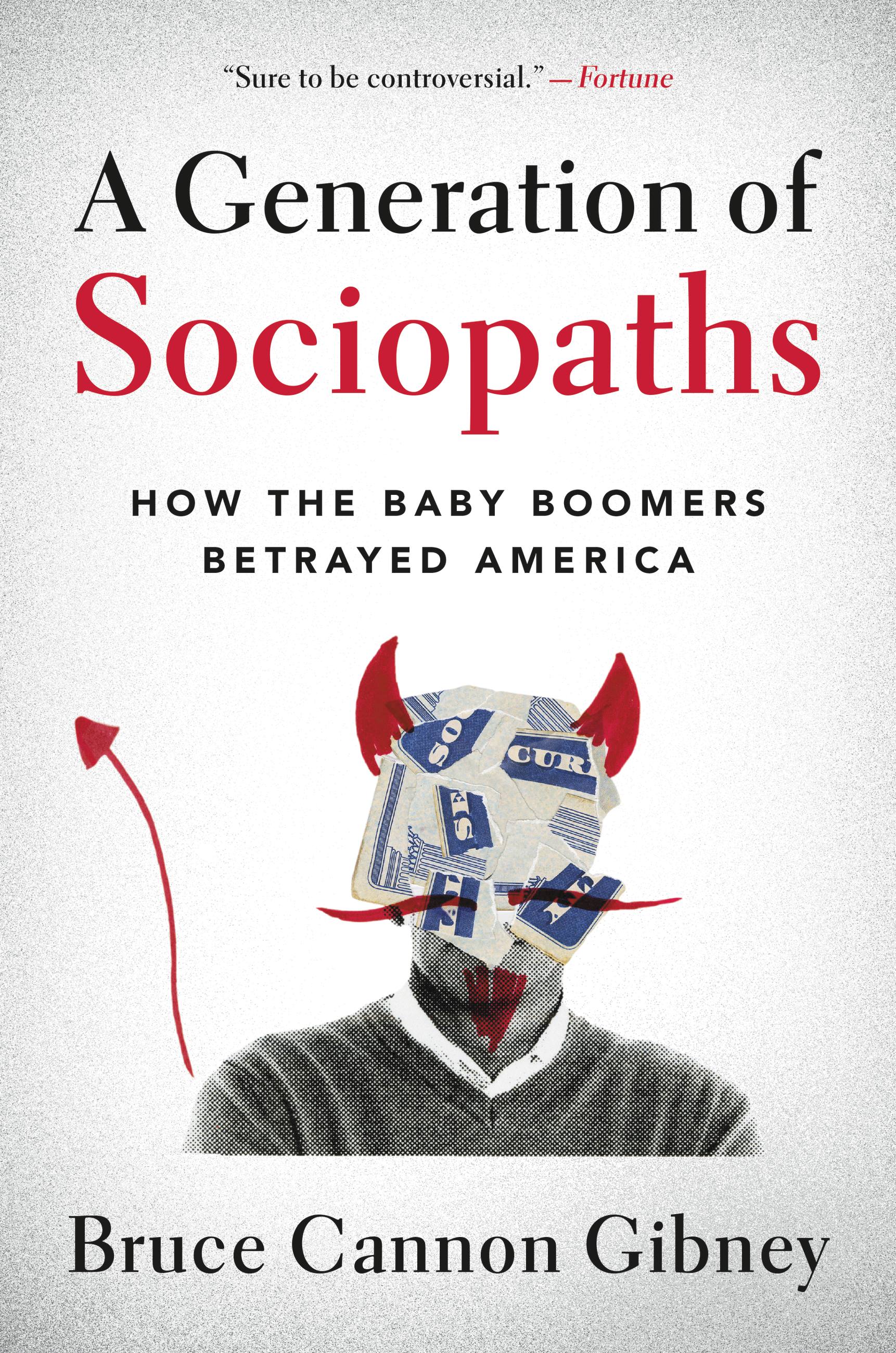
A Generation of Sociopaths In his "remarkable" (Men's Journal) and "controversial" (Fortune) book -- written in a "wry, amusing style" (The Guardian) -- Bruce Cannon Gibney shows how America was hijacked by the Boomers, a generation whose reckless self-indulgence degraded the foundations of American prosperity. In A Generation of Sociopaths, Gibney examines the disastrous policies of the most powerful generation in modern history, showing how the Boomers ruthlessly enriched themselves at the expense of future generations. Acting without empathy, prudence, or respect for facts--acting, in other words, as sociopaths--the Boomers turned American dynamism into stagnation, inequality, and bipartisan fiasco. The Boomers have set a time bomb for the 2030s, when damage to Social Security, public finances, and the environment will become catastrophic and possibly irreversible--and when, not coincidentally, Boomers will be dying off. Gibney argues that younger generations have a fleeting window to hold the Boomers accountable and begin restoring America. POLITICAL SCIENCE,Commentary & Opinion

The Fractured Republic Americans today are frustrated and anxious. Our economy is sluggish, and leaves workers insecure. Income inequality, cultural divisions, and political polarization increasingly pull us apart. Our governing institutions often seem paralyzed. And our politics has failed to rise to these challenges. No wonder, then, that Americans -- and the politicians who represent them -- are overwhelmingly nostalgic for a better time. The Left looks back to the middle of the twentieth century, when unions were strong, large public programs promised to solve pressing social problems, and the movements for racial integration and sexual equality were advancing. The Right looks back to the Reagan Era, when deregulation and lower taxes spurred the economy, cultural traditionalism seemed resurgent, and America was confident and optimistic. Each side thinks returning to its golden age could solve America's problems. In The Fractured Republic, Yuval Levin argues that this politics of nostalgia is failing twenty-first-century Americans. Both parties are blind to how America has changed over the past half century -- as the large, consolidated institutions that once dominated our economy, politics, and culture have fragmented and become smaller, more diverse, and personalized. Individualism, dynamism, and liberalization have come at the cost of dwindling solidarity, cohesion, and social order. This has left us with more choices in every realm of life but less security, stability, and national unity. Both our strengths and our weaknesses are therefore consequences of these changes. And the dysfunctions of our fragmented national life will need to be answered by the strengths of our decentralized, diverse, dynamic nation. Levin argues that this calls for a modernizing politics that avoids both radical individualism and a centralizing statism and instead revives the middle layers of society -- families and communities, schools and churches, charities and associations, local governments and markets. Through them, we can achieve not a single solution to the problems of our age, but multiple and tailored answers fitted to the daunting range of challenges we face and suited to enable an American revival. POLITICAL SCIENCE,Commentary & Opinion
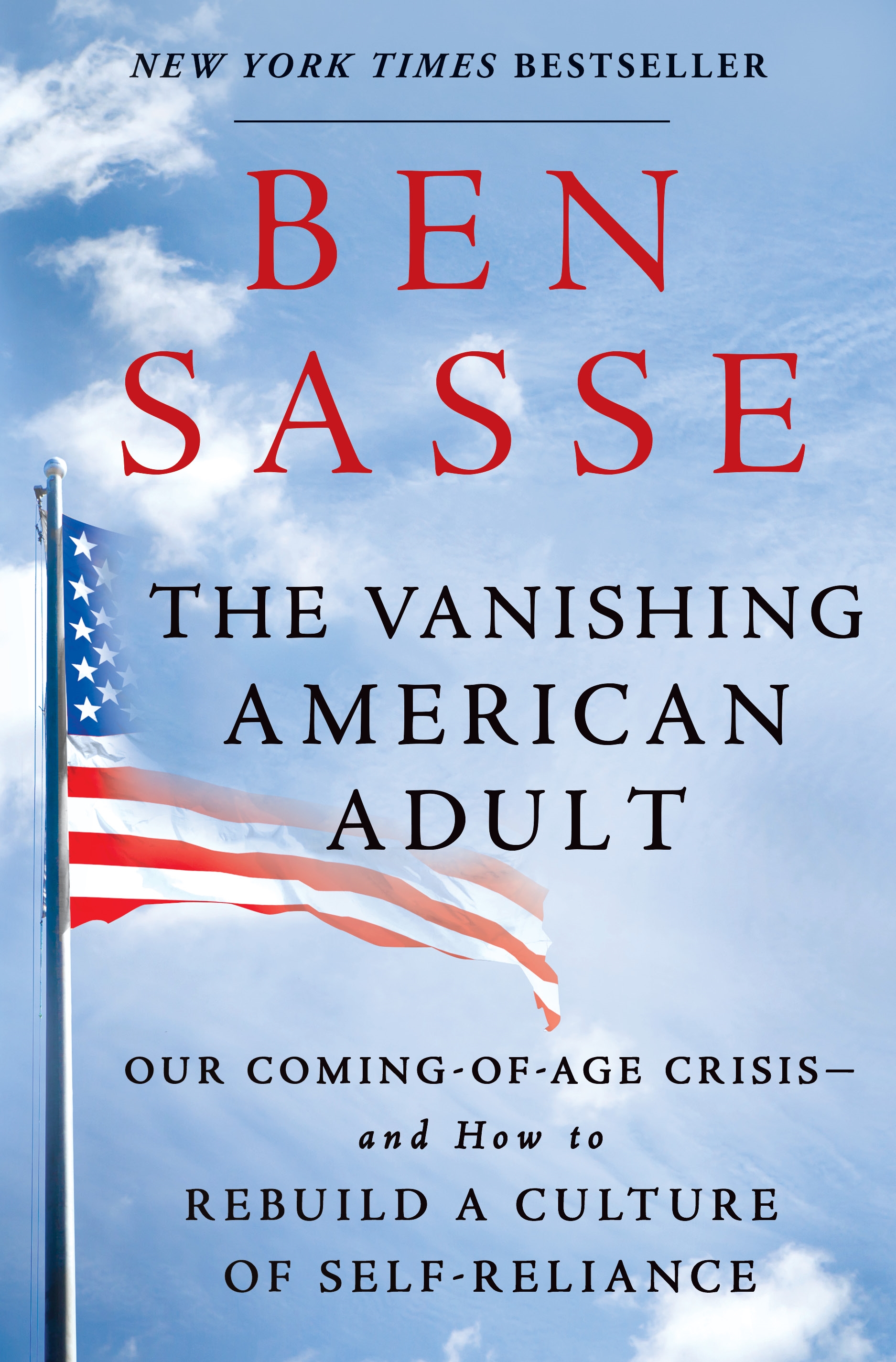
The Vanishing American Adult THE INSTANT NEW YORK TIMES BESTSELLER In an era of safe spaces, trigger warnings, and an unprecedented election, the country's youth are in crisis. Senator Ben Sasse warns the nation about the existential threat to America's future. Raised by well-meaning but overprotective parents and coddled by well-meaning but misbegotten government programs, America's youth are ill-equipped to survive in our highly-competitive global economy. Many of the coming-of-age rituals that have defined the American experience since the Founding: learning the value of working with your hands, leaving home to start a family, becoming economically self-reliant—are being delayed or skipped altogether. The statistics are daunting: 30% of college students drop out after the first year, and only 4 in 10 graduate. One in three 18-to-34 year-olds live with their parents. From these disparate phenomena: Nebraska Senator Ben Sasse who as president of a Midwestern college observed the trials of this generation up close, sees an existential threat to the American way of life. In The Vanishing American Adult, Sasse diagnoses the causes of a generation that can't grow up and offers a path for raising children to become active and engaged citizens. He identifies core formative experiences that all young people should pursue: hard work to appreciate the benefits of labor, travel to understand deprivation and want, the power of reading, the importance of nurturing your body—and explains how parents can encourage them. Our democracy depends on responsible, contributing adults to function properly—without them America falls prey to populist demagogues. A call to arms, The Vanishing American Adult will ignite a much-needed debate about the link between the way we're raising our children and the future of our country. POLITICAL SCIENCE,Commentary & Opinion
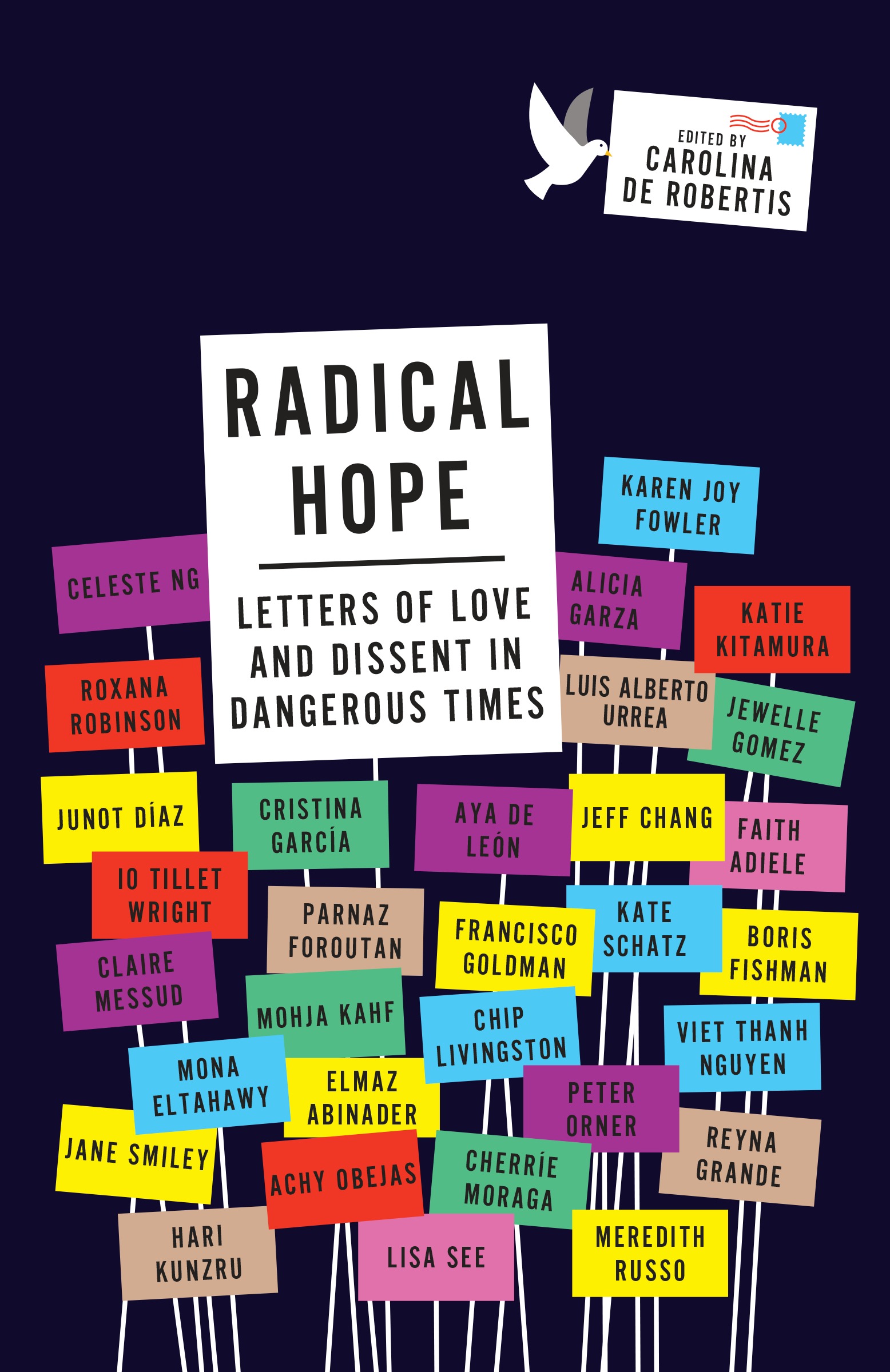
Radical Hope Radical Hope is a collection of letters—to ancestors, to children five generations from now, to strangers in grocery lines, to any and all who feel weary and discouraged—written by award-winning novelists, poets, political thinkers, and activists. Provocative and inspiring, Radical Hope offers readers a kaleidoscopic view of the love and courage needed to navigate this time of upheaval, uncertainty, and fear, in view of the recent US presidential election. Including letters by Junot Díaz, Alicia Garza, Roxana Robinson, Lisa See, Jewelle Gomez, Hari Kunzru, Faith Adiele, Parnaz Foroutan, Chip Livingston, Mohja Kahf, Achy Obejas, Viet Thanh Nguyen, Cherríe Moraga, Kate Schatz, Boris Fishman, Karen Joy Fowler, Elmaz Abinader, Aya de León, Jane Smiley, Luis Alberto Urrea, Mona Eltahawy, Jeff Chang, Claire Messud, Meredith Russo, Reyna Grande, Katie Kitamura, iO Tillett Wright, Francisco Goldman, Celeste Ng, Peter Orner, and Cristina García. POLITICAL SCIENCE,Commentary & Opinion
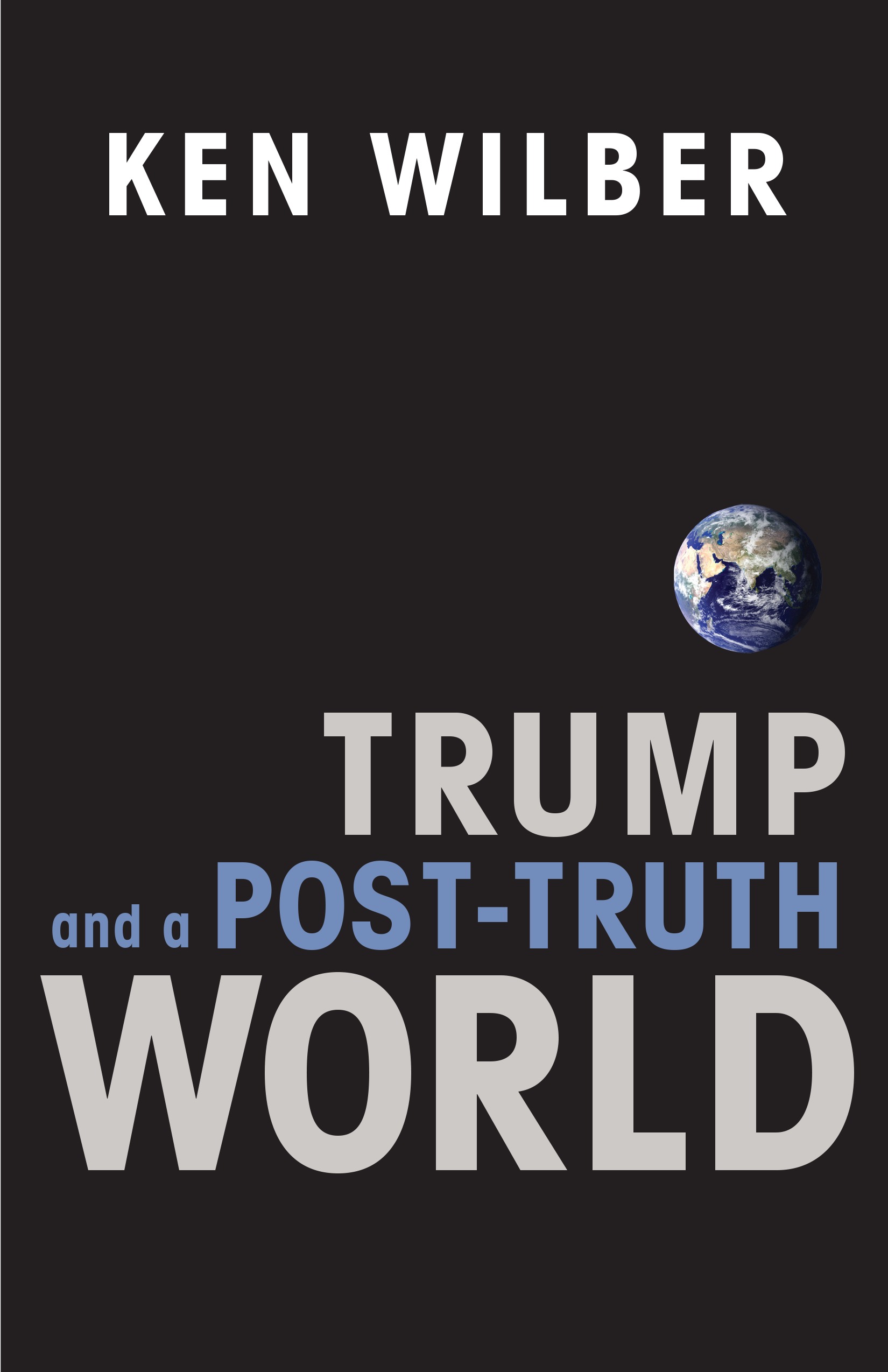
Trump and a Post-Truth World A provocative and balanced examination of our current social and political situation—by a cutting–edge philosopher of our times. The world is in turmoil. As populist waves roil in the UK, Europe, Turkey, Russia, Asia—and most visibly, the U.S., with the election of Donald Trump—nationalist and extremist political forces threaten the progress made over many decades. Democracies are reeling in the face of nihilism and narcissism. How did we get here? And how, with so much antagonism, cynicism, and discord, can we mend the ruptures in our societies? In this provocative work, philosopher Ken Wilber applies his Integral approach to explain how we arrived where we are and why there is cause for hope. He lays much of the blame on a failure at the progressive, leading edge of society. This leading edge is characterized by the desire to be as just and inclusive as possible, and to it we owe the thrust toward women’s rights, the civil rights movement, the environmental movement, and the concern for oppression in all its forms. This is all evolutionarily healthy. But what is unhealthy is a creeping postmodernism that is elitist, “politically correct,” insistent on an egalitarianism that is itself paradoxically hierarchical, and that looks down on “deplorables.” Combine this with the techno-economic demise of many traditional ways of making a living, and you get an explosive mixture. As Wilber says, for some Trump voters: “Everywhere you are told that you are fully equal and deserve immediate and complete empowerment, yet everywhere you are denied the means to actually achieve it. You suffocate, you suffer, and you get very, very mad.” It is only when members of society’s leading edge can heal themselves that a new, Integral evolutionary force can emerge to move us beyond the social and political turmoil of our current time to offer genuine leadership toward greater wholeness. POLITICAL SCIENCE,Commentary & Opinion
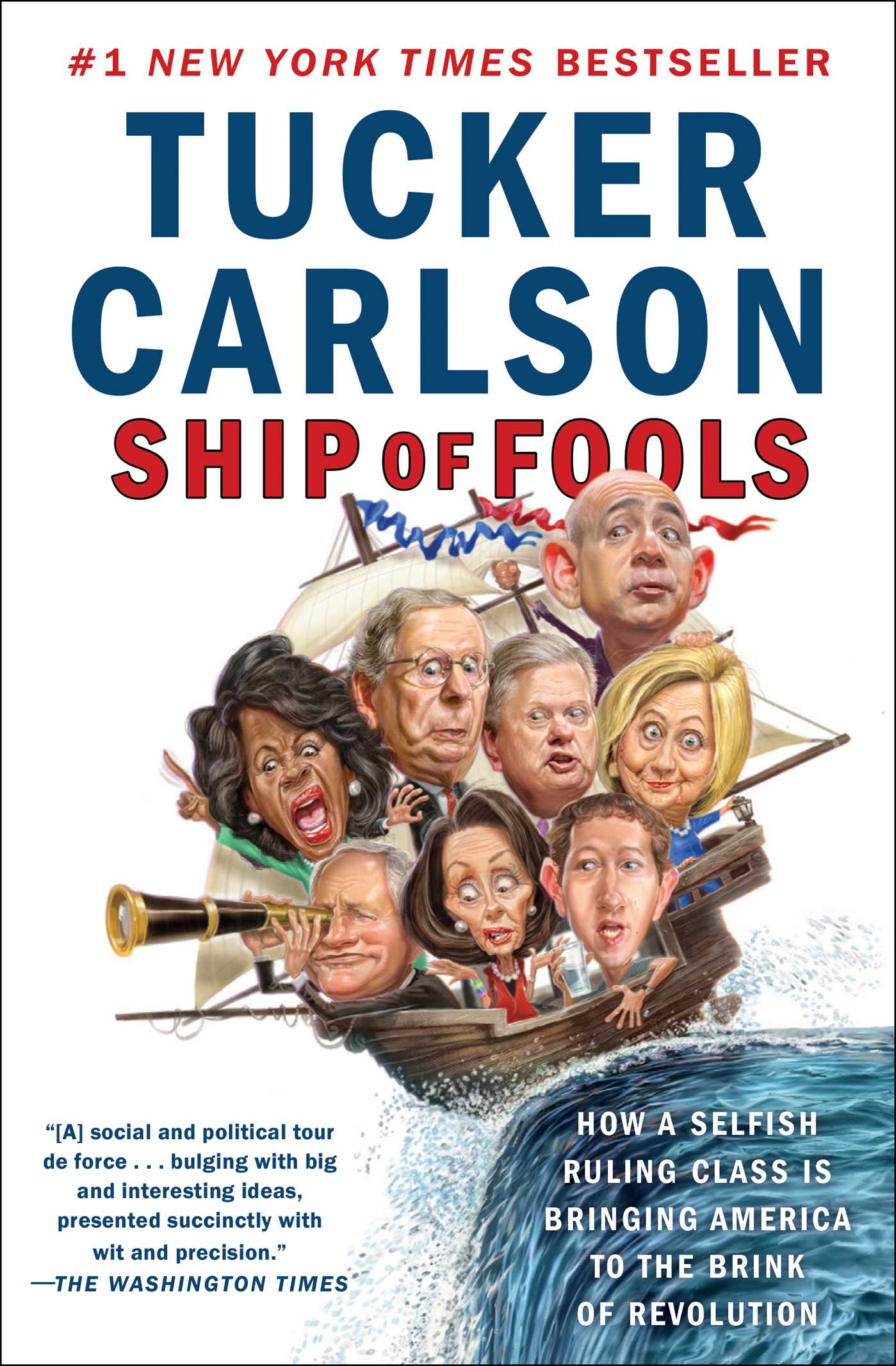
Ship of Fools The host of Fox News Channel’s Tucker Carlson Tonight offers a blistering critique of the new American ruling class, the elites of both parties, who have taken over the ship of state, leaving the rest of us, the citizen-passengers, to wonder: How do we put the country back on course? POLITICAL SCIENCE,Commentary & Opinion
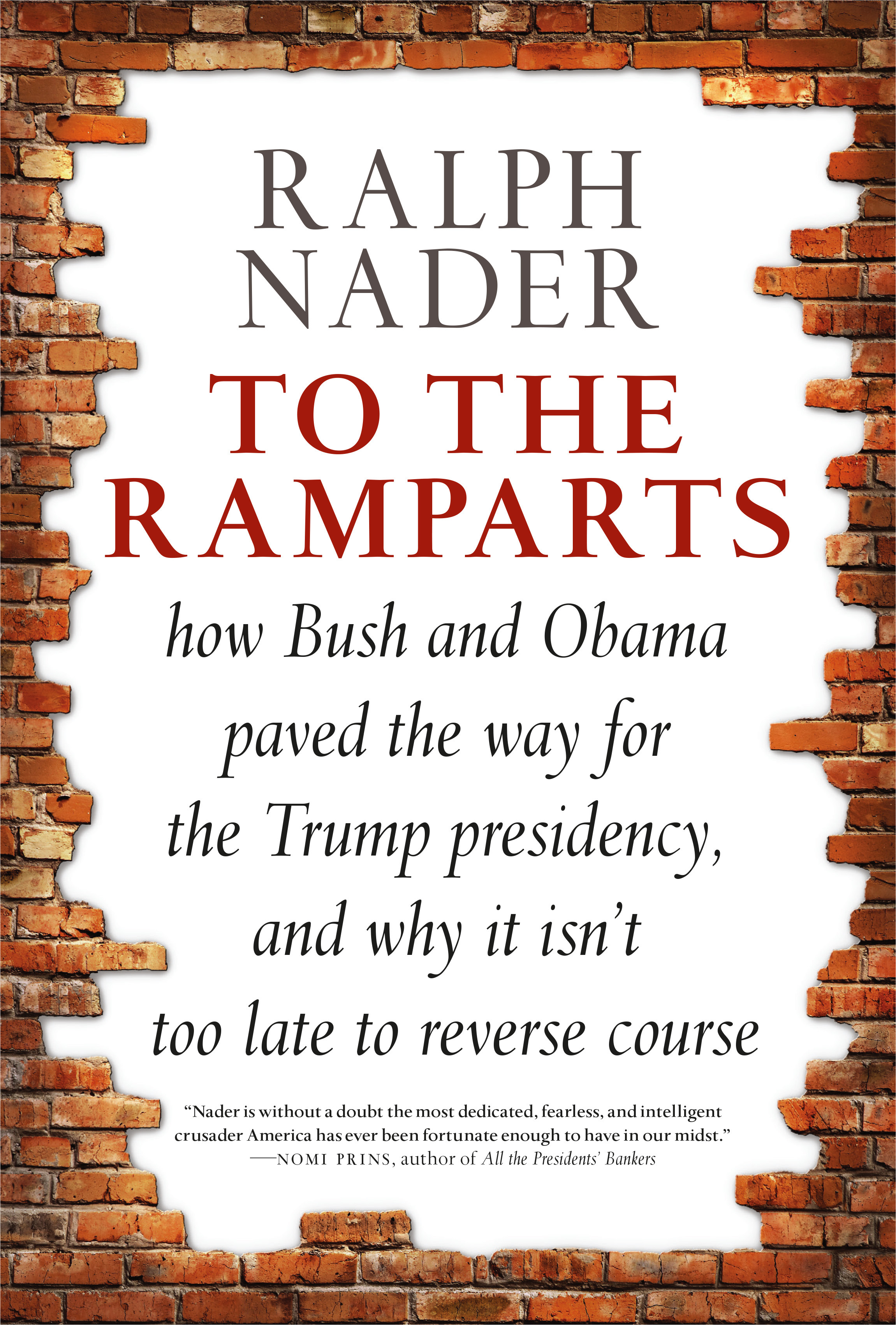
To the Ramparts America’s number one citizen Ralph Nader’s latest book shows us how unchecked corporate power has led to the wrecking ball that is the Trump presidency. Nader brings together the outrages of the Trump administration with the key flaws and failures of the previous administrations—both Republican and Democratic—that have led our nation to its current precipice. It’s all in the details and Ralph Nader knows them all. Trump didn’t come out of nowhere. Bush and Obama led the way. Writing as a Washington, DC, activist and people’s advocate for over fifty years―someone who has saved more lives and caused more impactful legislation to be enacted than almost any sitting president or legislator—Nader shows how Trump’s crimes and misdemeanors followed the path of no resistance of the Obama, Bush and Clinton regimes, which ushered in the extreme rise of corporate power and the abandonment of the poor and middle classes. POLITICAL SCIENCE,Commentary & Opinion
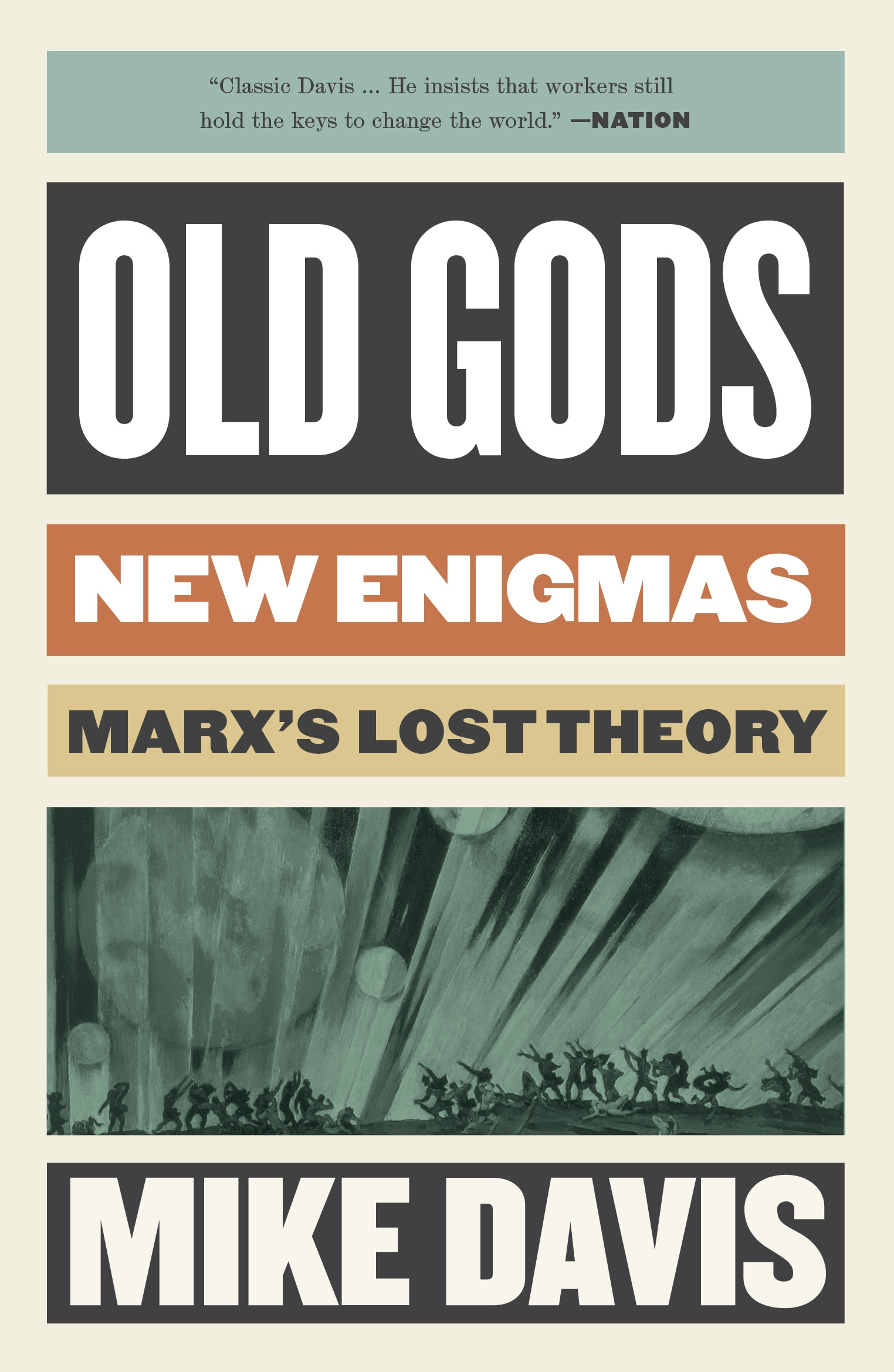
Old Gods, New Enigmas Is revolution possible in the age of the Anthropocene? Marx has returned, but which Marx? Recent biographies have proclaimed him to be an emphatically nineteenth-century figure, but in this book, Mike Davis’s first directly about Marx and Marxism, a thinker comes to light who speaks to the present as much as the past. In a series of searching, propulsive essays, Davis, the bestselling author of City of Quartz and recipient of a MacArthur Fellowship, explores Marx’s inquiries into two key questions of our time: Who can lead a revolutionary transformation of society? And what is the cause—and solution—of the planetary environmental crisis? Davis consults a vast archive of labor history to illuminate new aspects of Marx’s theoretical texts and political journalism. He offers a “lost Marx,” whose analyses of historical agency, nationalism, and the “middle landscape” of class struggle are crucial to the renewal of revolutionary thought in our darkening age. Davis presents a critique of the current fetishism of the “anthropocene,” which suppresses the links between the global employment crisis and capitalism’s failure to ensure human survival in a more extreme climate. In a finale, Old Gods, New Enigmas looks backward to the great forgotten debates on alternative socialist urbanism (1880–1934) to find the conceptual keys to a universal high quality of life in a sustainable environment. POLITICAL SCIENCE,Commentary & Opinion

The Gutfeld Monologues T he New York Times bestselling collection from FOX News star Greg Gutfeld features his best and pithiest monologues on the current state of the world, covering everything from pop culture to politics, annotated for the modern day with all new content. “Wherever I go, I am hit repeatedly by the same question: where can I read your monologues? It should be easy to find these little nuggets of knowledge.†Well, now it is. In the past few years, Fox News host Greg Gutfeld has covered everything from crazed academics, to unhinged celebrities, to the wildest election in recent history on his shows The Five and The Greg Gutfeld Show. In The Gutfeld Monologues, he brings together his best and favorite monologues in this funny, unconventional collection for new and longtime fans alike. Scored through with marginal edits, scratch-outs, 20/20 hindsight, and up-to-the-minute commentary on what he got wrong, this book isn’t your typical anthology collection. With his signature humor, wit, and insight, Greg explains it all in this memorable collection about some of our country’s most crucial—and not so crucial—modern moments. POLITICAL SCIENCE,Commentary & Opinion

Trump's Enemies Corey R. Lewandowski and David N. Bossie, the authors of the blockbuster, Let Trump Be Trump: the Inside Story of His Rise to the Presidency, are back with their next New York Times bestseller. The assault on the 45th president began immediately following Donald J. Trump's victory in the 2016 presidential election. It was then that Democrats concocted the absurd story of Russian spies and international plots as an excuse for Hillary's humiliating defeat. It was in those early days, too, during the presidential transition, when enemies of Donald Trump began to tunnel their way into the White House with the intent to undermine the president and subvert his agenda. Perhaps there are no two people better to tell what is certain to be the story of our lifetime than Corey R. Lewandowski and David N. Bossie. The guys in the room who brought you the bestselling account of the 2016 Donald J. Trump for President campaign, Let Trump Be Trump, Lewandowski and Bossie now offer a first-hand account of what is, perhaps, the battle for the life of our very democracy. Using unparalleled, behind-the-scenes sourcing from inside the White House and on Capitol Hill, and access to the president and other key players, Trump's Enemies offers a never-before-seen look deep into the forces aligned against the president. Lewandowski and Bossie were present in Trump Tower and at Bedminster during the presidential transition and saw the events that gave root to the unelected "resistance" in the White House today. Bossie was witness to the moment the fake Russia investigation was enacted by James Comey, who legitimized the phony "Steele dossier" by presenting it to the new president-elect. A close confidant of the president, Lewandowski knows what goes on behind the West Wing walls as well as anyone. But Trump's Enemies is also the story of how President Trump is fighting back. In the face of a gale of media disinformation and the looming black cloud of Mueller's politically motivated investigation, President Trump has still managed to accomplish more than any of his predecessor in the short time he's been in office. Often traveling with the president on Air Force One to rallies around the country, Lewandowski and Bossie tell, as no one else can, the story of Donald Trump bringing his message to the people who are the only ones who should decide the future of his presidency-the American voters. POLITICAL SCIENCE,Commentary & Opinion

Let Me Finish The instant New York Times-bestselling memoir from the outspoken former governor--an "explosive" (Guardian) "must read" (Hugh Hewitt) account of Chris Christie's life in politics including his "not to miss" (Entertainment Weekly) insights into Donald Trump. After dropping out of the 2016 presidential race, Chris Christie stunned the political world by becoming the first major official to endorse Donald Trump. A friend of Trump's for fifteen years, the two-term New Jersey governor understood the future president as well as anyone in the political arena--and Christie quickly became one of Trump's most trusted advisers. Tapped with running Trump's transition team, Christie was nearly named his running mate. But within days of Trump's surprise victory over Hillary Clinton, Christie was in for his own surprise: he was being booted out. In Let Me Finish, Christie sets the record straight about his tenure as a corruption-fighting prosecutor and a Republican running a Democratic state, as well as what really happened on the 2016 campaign trail and inside Trump Tower. Christie takes readers inside the ego-driven battles for Trump's attention among figures like Steve Bannon, Corey Lewandowksi, Reince Priebus, Kellyanne Conway, Jeff Sessions, and Paul Manafort. He shows how the literal trashing of Christie's transition plan put the new administration in the hands of self-serving amateurs, all but guaranteeing the Trump presidency's shaky start. Christie also addresses hot-button issues from his own years in power, including what really went down during Bridgegate. And, for the first time, Christie tells the full story of the Kushner saga: how, as a federal prosecutor, Christie put Jared Kushner's powerful father behind bars--a fact Trump's son-in-law makes Christie pay for later. Packed with news-making revelations and told with the kind of bluntness few politicians can match, Christie's memoir is an essential guide to understanding the Trump presidency. POLITICAL SCIENCE,Commentary & Opinion

What's Wrong with Pakistan? A courageous, comprehensive and no-holds-barred account, by a veteran journalist, of a 66-year-old nation that is still trying to find its identity and fighting its own demons . . . Beginning with the ‘genetic defect’ that Pakistan was born with, Babar Ayaz highlights the numerous problems faced by Pakistan today that have arisen as a result of the country’s foundation being based on religion. What Quaid-e-Azam Muhammad Ali Jinnah managed to achieve as a separate homeland inAugust 1947 is today being consumed by religious fanaticism. Ayaz attributes such a state of affairs to the Islamization of Pakistani laws, which are in conflict with the twenty-first century value systems. The author next pinpoints how Jinnah failed to recognize the ethno-linguistic diversity of the Pakistan he had created, which needed proper distribution of power between the Centre and the states in the then-existent West Pakistan and East Pakistan. He describes how the centralization of power and the imposition of a single language for both wings of the country led to the dismemberment of Pakistan and the creation of Bangladesh in 1971. The book also analyzes the ‘unwritten national security policy’ of Pakistan and how it has dictated its foreign policy. Relations with the US, India, China, Saudi Arabia, Iran and Afghanistan are discussed visà-vis the overall national security policy. The author contends that the rise of fundamentalism is a global phenomenon, but in Pakistan, it has given birth to a plethora of Islamic militant groups covertly supported by the Pakistani intelligence services. Pakistan has been branded as ‘the most dangerous state of the world’ and the ‘epicentre of terrorism’. He laments the fact that attempts to present the peaceful side of Islam are extremely feeble because of the dominance of the pro-jihad elements, which are pushing the country into a civil war-like situation. In spite of several years of attempts at indoctrination of the people through mass media and educational institutions, in Pakistan, the anti-Indian feelings and extreme stands on Kashmir have been limited. Ayaz believes that India and the developed world would have to help by being more accommodating and understanding, so that the people of Pakistan can re-invent their country. Without moving towards secularism, the author warns, Pakistan will remain at war with itself as it is torn between the twenty-first century and medieval religious value systems. POLITICAL SCIENCE,Commentary & Opinion
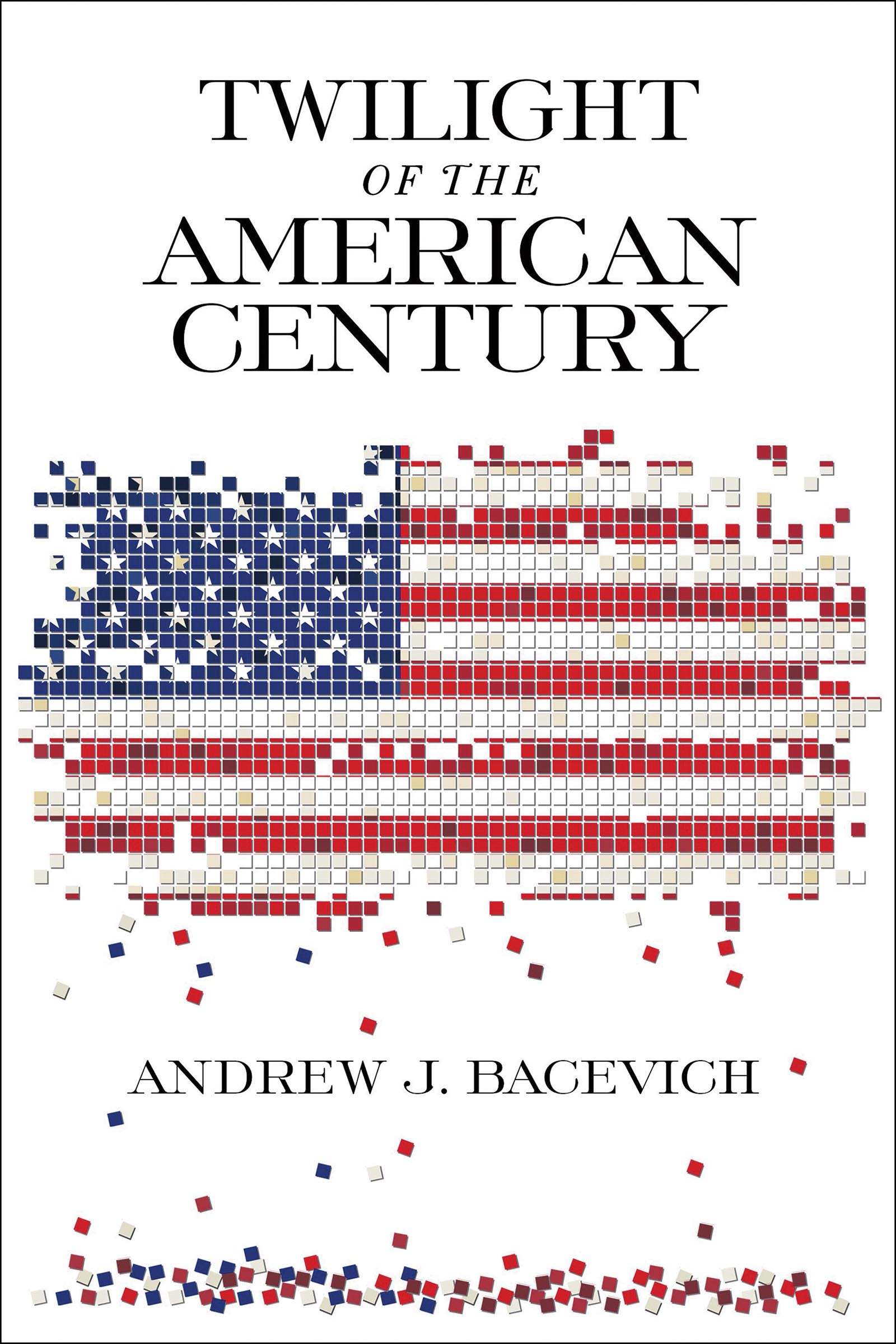
Twilight of the American Century Bacevich examines the U.S. response to September 11th and how it has radically affected the way Americans see themselves and their nation’s place in the world. POLITICAL SCIENCE,Commentary & Opinion
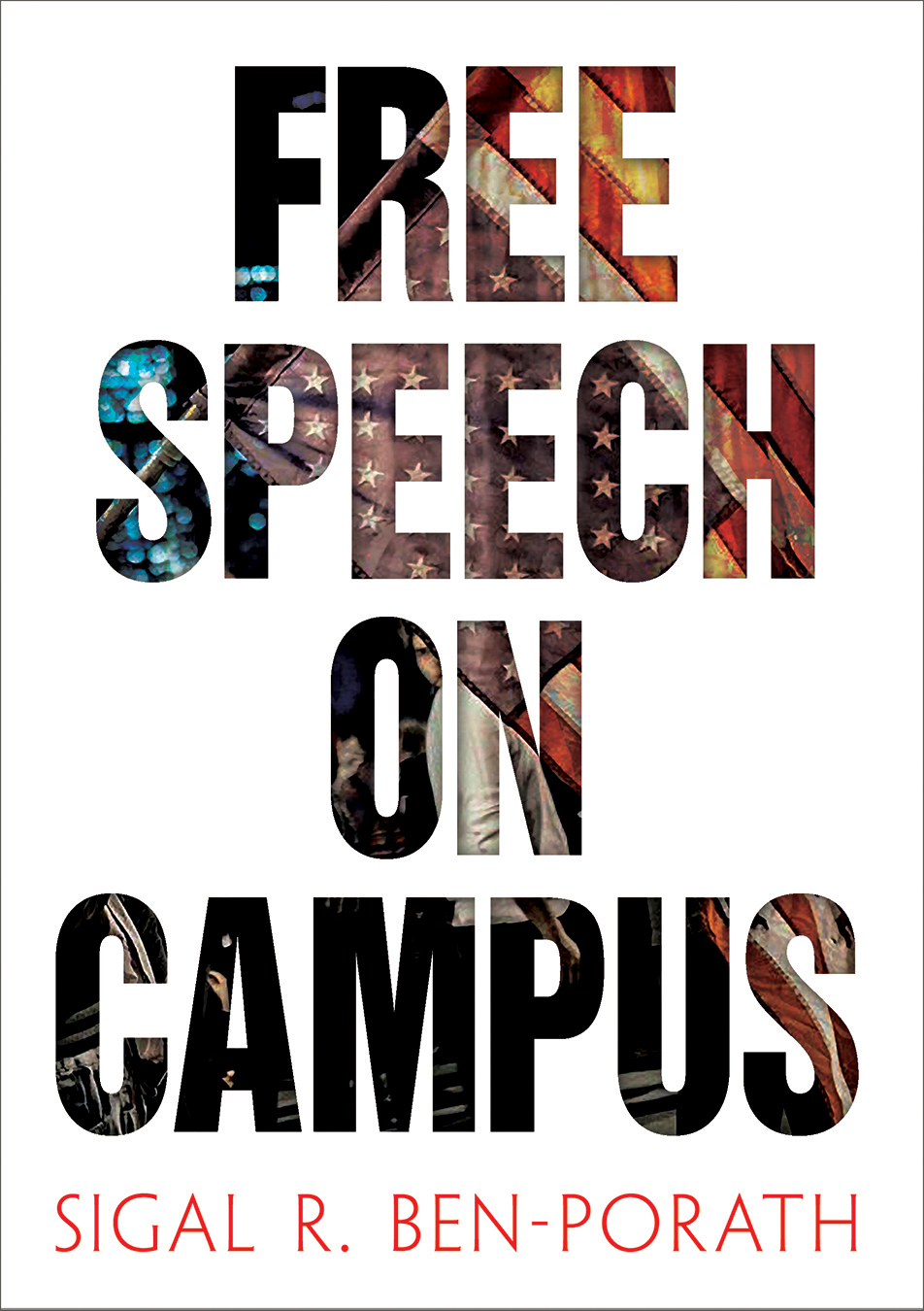
Free Speech on Campus In Free Speech on Campus, political philosopher Sigal Ben-Porath offers a useful framework for thinking about free-speech controversies surrounding trigger warnings, safe spaces, and speech that verges on hate. Everyone with a stake in campus debates will find something valuable in her illuminating discussion of these critical issues. POLITICAL SCIENCE,Commentary & Opinion
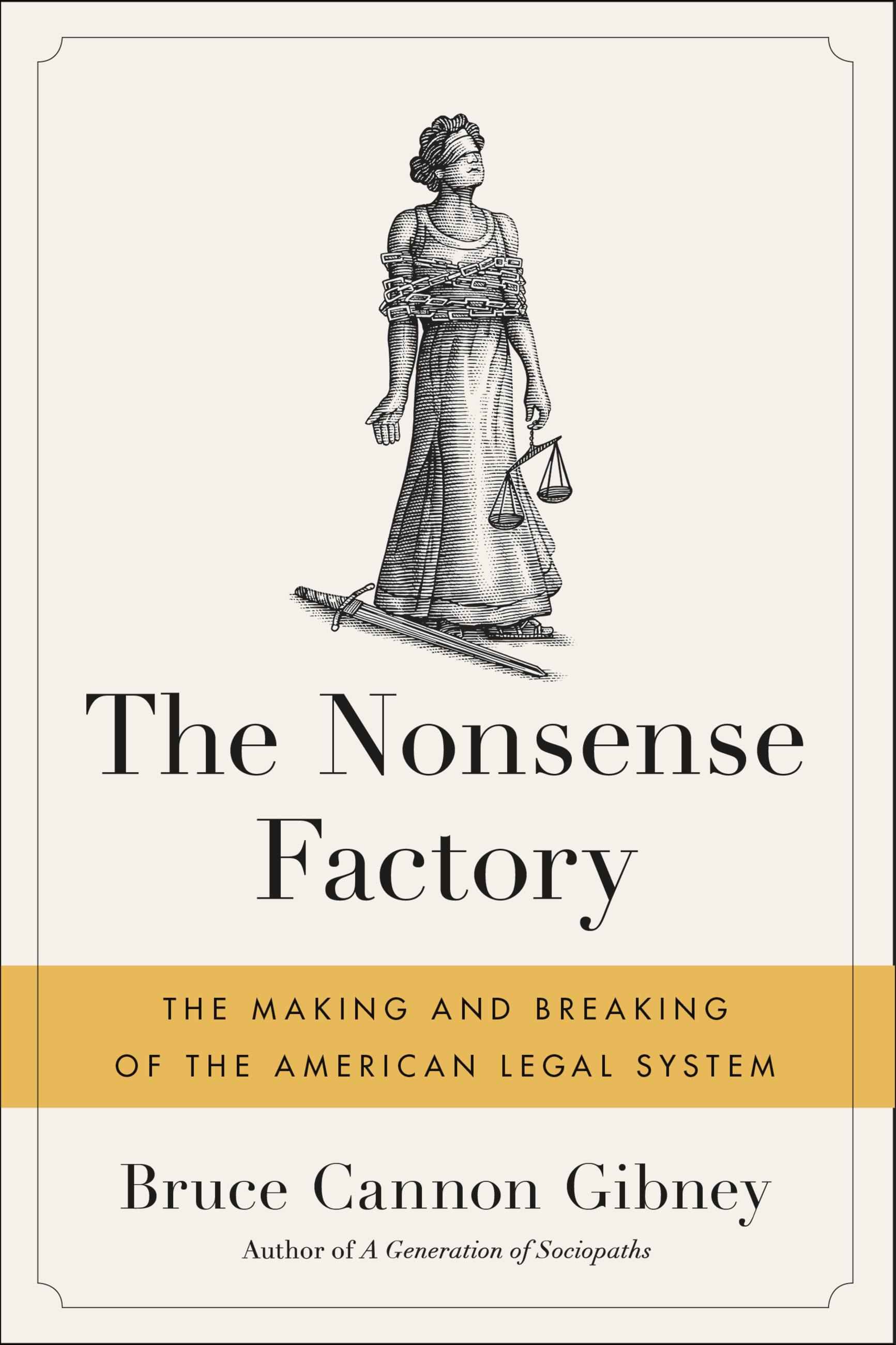
The Nonsense Factory A withering and witty examination of how the American legal system, burdened by complexity and untrammeled growth, fails Americans and threatens the rule of law itself, by the acclaimed author of A Generation of Sociopaths. Our trial courts conduct hardly any trials, our correctional systems do not correct, and the rise of mandated arbitration has ushered in a shadowy system of privatized "justice." Meanwhile, our legislators can't even follow their own rules for making rules, while the rule of law mutates into a perpetual state of emergency. The legal system is becoming an incomprehensible farce. How did this happen? In The Nonsense Factory, Bruce Cannon Gibney shows that over the past seventy years, the legal system has dangerously confused quantity with quality and might with legitimacy. As the law bloats into chaos, it staggers on only by excusing itself from the very commands it insists that we obey, leaving Americans at the mercy of arbitrary power. By examining the system as a whole, Gibney shows that the tragedies often portrayed as isolated mistakes or the work of bad actors -- police misconduct, prosecutorial overreach, and the outrages of imperial presidencies -- are really the inevitable consequences of law's descent into lawlessness. The first book to deliver a lucid, comprehensive overview of the entire legal system, from the grandeur of Constitutional theory to the squalid workings of Congress, The Nonsense Factory provides a deeply researched and witty examination of America's state of legal absurdity, concluding with sensible options for reform. POLITICAL SCIENCE,Commentary & Opinion

DARK AGENDA In Dark Agenda, New York Times bestselling author David Horwitz exposes not only the progressive war against Christianity, but also a war against America and its founding principles, which are Christian in their origin. Dark Agenda is about an embattled religion, but most of all, it is about our imperiled nation. Tackling a broad range of issues from prayer in the schools to the globalist mindset, Horowitz traces the anti-Christian movement to its roots in communism. When the communist empire fell, progressives did not want to give up their utopian anti-God illusions, so instead they merely changed the name of their dream. Instead of “communism,†progressives have re-branded their movement as “social justice.†Dark Agenda shows how the progressives are prepared to use any means necessary to stifle their opponents who support the concepts of religious liberty that America was founded on, and how the battle to destroy Christianity is really the battle to destroy America. POLITICAL SCIENCE,Commentary & Opinion
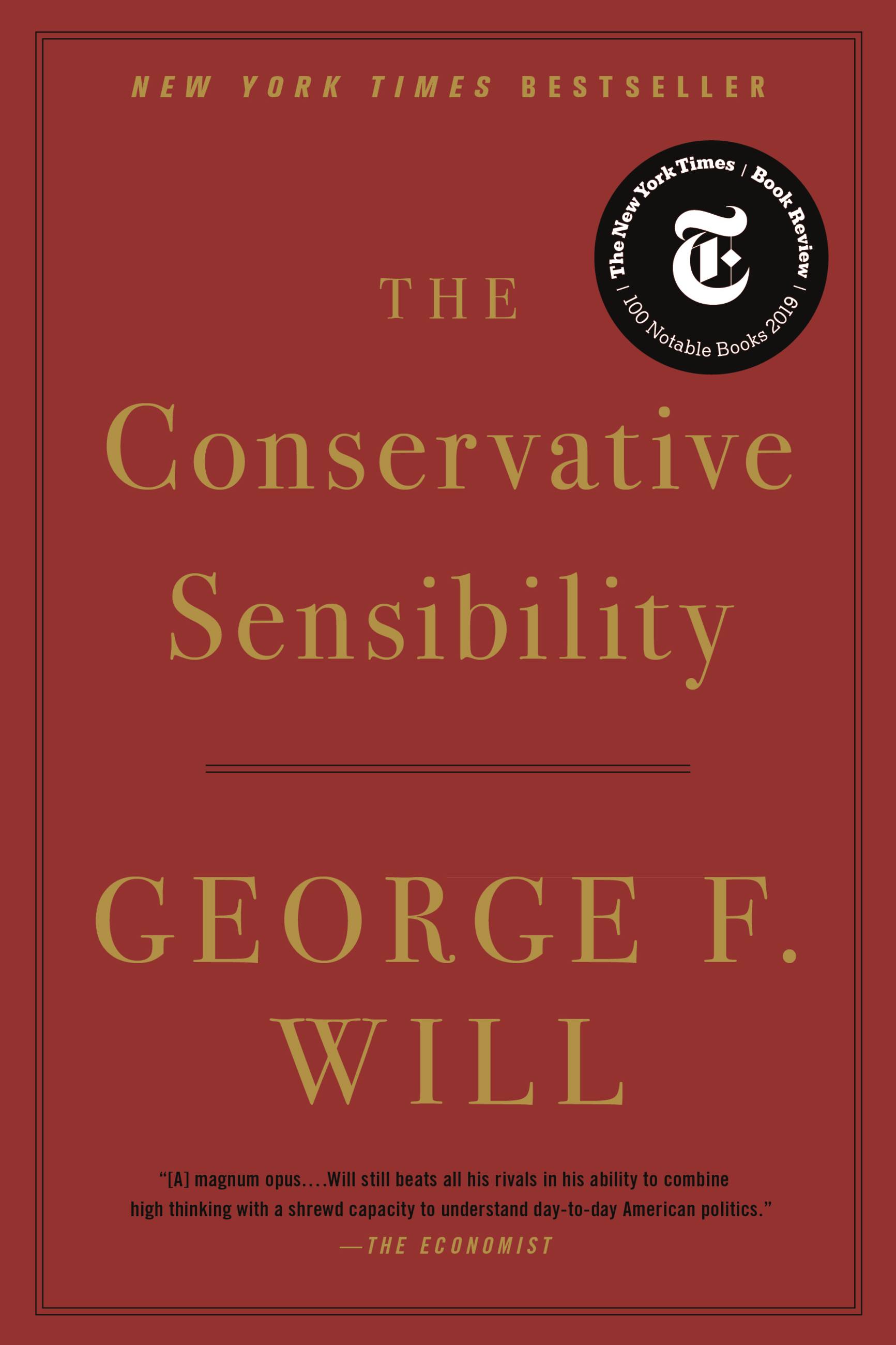
The Conservative Sensibility The Pulitzer Prize-winning columnist's "astonishing" and "enthralling" New York Times bestseller and Notable Book about how the Founders' belief in natural rights created a great American political tradition (Booklist) -- "easily one of the best books on American Conservatism ever written" (Jonah Goldberg). For more than four decades, George F. Will has attempted to discern the principles of the Western political tradition and apply them to America's civic life. Today, the stakes could hardly be higher. Vital questions about the nature of man, of rights, of equality, of majority rule are bubbling just beneath the surface of daily events in America. The Founders' vision, articulated first in the Declaration of Independence and carried out in the Constitution, gave the new republic a framework for government unique in world history. Their beliefs in natural rights, limited government, religious freedom, and in human virtue and dignity ushered in two centuries of American prosperity. Now, as Will shows, conservatism is under threat -- both from progressives and elements inside the Republican Party. America has become an administrative state, while destructive trends have overtaken family life and higher education. Semi-autonomous executive agencies wield essentially unaccountable power. Congress has failed in its duty to exercise its legislative powers. And the executive branch has slipped the Constitution's leash. In the intellectual battle between the vision of Founding Fathers like James Madison, who advanced the notion of natural rights that pre-exist government, and the progressivism advanced by Woodrow Wilson, the Founders have been losing. It's time to reverse America's political fortunes. Expansive, intellectually thrilling, and written with the erudite wit that has made Will beloved by millions of readers, The Conservative Sensibility is an extraordinary new book from one of America's most celebrated political writers. POLITICAL SCIENCE,Commentary & Opinion
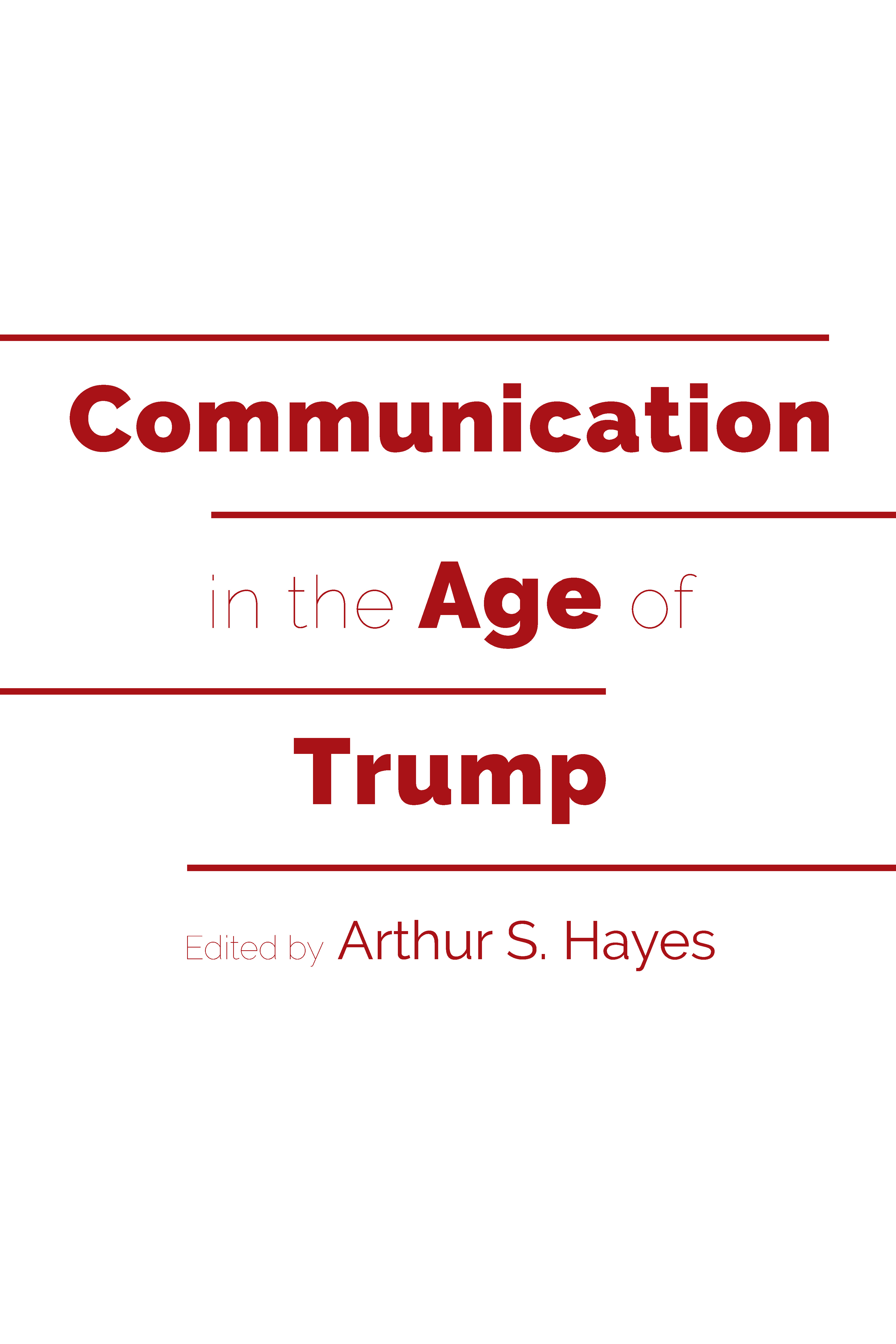
Communication in the Age of Trump This collection of essays and studies covers the 2016 presidential campaign and the first year of the Trump presidency and is suitable for communication and political science students and scholars. POLITICAL SCIENCE,Commentary & Opinion
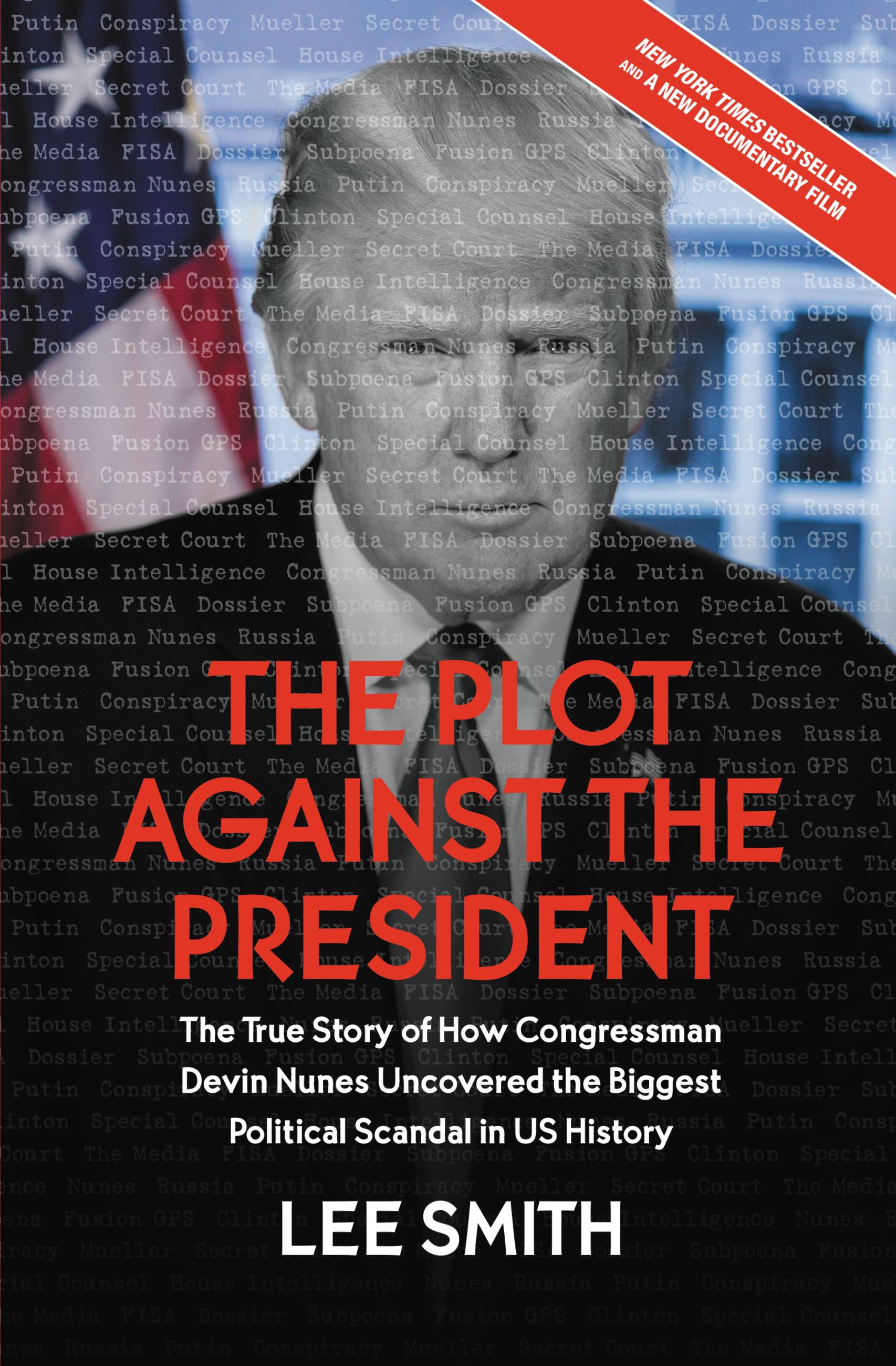
The Plot Against the President Investigative journalist Lee Smith uses his unprecedented access to Congressman Devin Nunes, former head of the House Intelligence Committee, to expose the deep state operation against the president -- and the American people. Investigative journalist Lee Smith's The Plot Against the Presidenttells the story of how Congressman Devin Nunes uncovered the operation to bring down the commander-in-chief. While popular opinion holds that Russia subverted democratic processes during the 2016 elections, the real damage was done not by Moscow or any other foreign actor. Rather, this was a slow-moving coup engineered by a coterie of the American elite, the "deep state," targeting not only the president, but also the rest of the country. The plot officially began July 31, 2016 with the counterintelligence investigation that the FBI opened to probe Russian infiltration of Donald Trump's presidential campaign. But the bureau never followed any Russians. In fact, it was an operation to sabotage Trump, the candidate, then president-elect, and finally the presidency. The conspirators included political operatives, law enforcement and intelligence officials, and the press. The plot was uncovered by Nunes, chairman of the House Intelligence Committee, and his investigative team. They understood that the target of the operation wasn't just Trump, but rather the institutions that sustain our republic. A country where operatives use the intelligence and security services to protect their privileges by spying on Americans, coordinating with the press, and using extra-constitutional means to undermine an election then undo a presidency is more like the third world than the republic envisioned by the founding fathers. Without Nunes and his team, the plot against the president -- and against the country -- never would have been revealed. Told from the perspective of Nunes and his crack investigators -- men and women who banded together to do the right thing at a crucial moment for our democracy -- the story of the biggest political scandal in a generation reads like a great detective novel, feels like a classic cowboy movie. The congressman from the cattle capital of California really did fight corruption in Washington. Devin Nunes took on the "deep state." POLITICAL SCIENCE,Commentary & Opinion
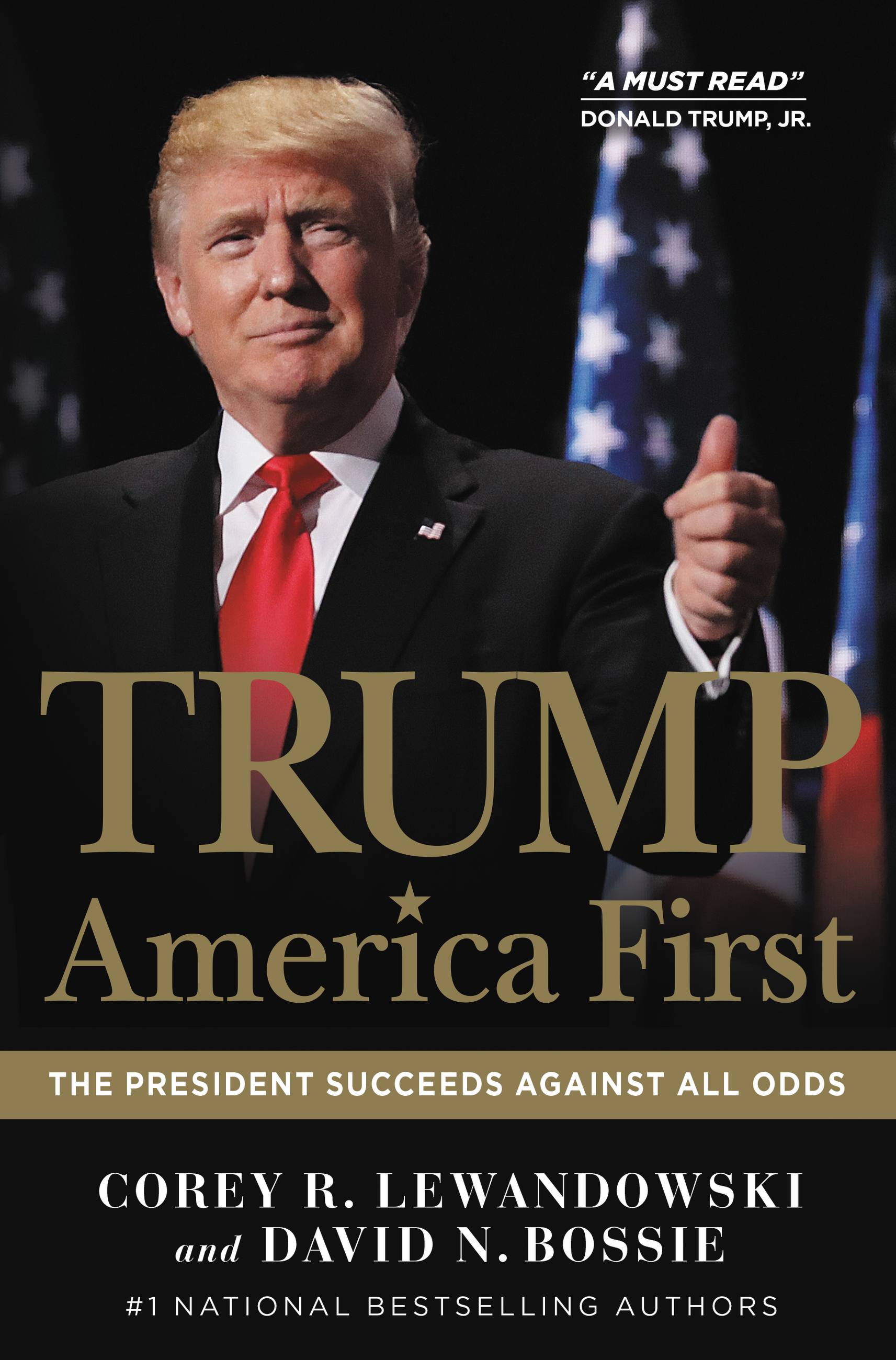
Trump New York Times bestselling authors and close advisors to the president Corey R. Lewandowski and David N. Bossie write from the front lines of Trump's battle to keep America great. Trump: America First gives the reader a firsthand and inside account of the Trump administration's battle for the soul of America. As we face the most critical presidential election of our lifetimes, we find ourselves buried in an avalanche of political spin, candidate talking points, and slick campaign ads. Then, just as you're ready to give up, along comes a book that makes sense of a political time like none that have come before. Written with the urgency of a countdown and by President Trump's two top outside political advisors and friends, Corey R. Lewandowski and David N. Bossie, Trump: America First blasts through the nonsense to deliver a first-hand account of the Trump presidency and reelection campaign during its most tumultuous time. From the COVID-19 shutdown in March to the campaign leadership shakeup and reset in July, Lewandowski and Bossie are present for every big moment, and now the reader is too. With unprecedented access to President Trump, the authors take us inside the Oval Office, aboard Air Force One, and backstage at Trump rallies. As they did in their first two blockbuster New York Times bestsellers, Lewandowski and Bossie show a side of the president few get to see. Along the way, Lewandowski and Bossie also tell of their own battles with the forces aligned against the president, and bring us inside the White House to the rough-and-tumble world of Trump's West Wing. Trump: America First also makes a case for electing Donald Trump to a second term. From revamping our trade with China to replacing NAFTA, from NATO to Kim Jong Un, Donald Trump leaves Joe Biden in the dust. Written with the authors' usual wit and political insight, America First is truly a book a political book for our time. POLITICAL SCIENCE,Commentary & Opinion
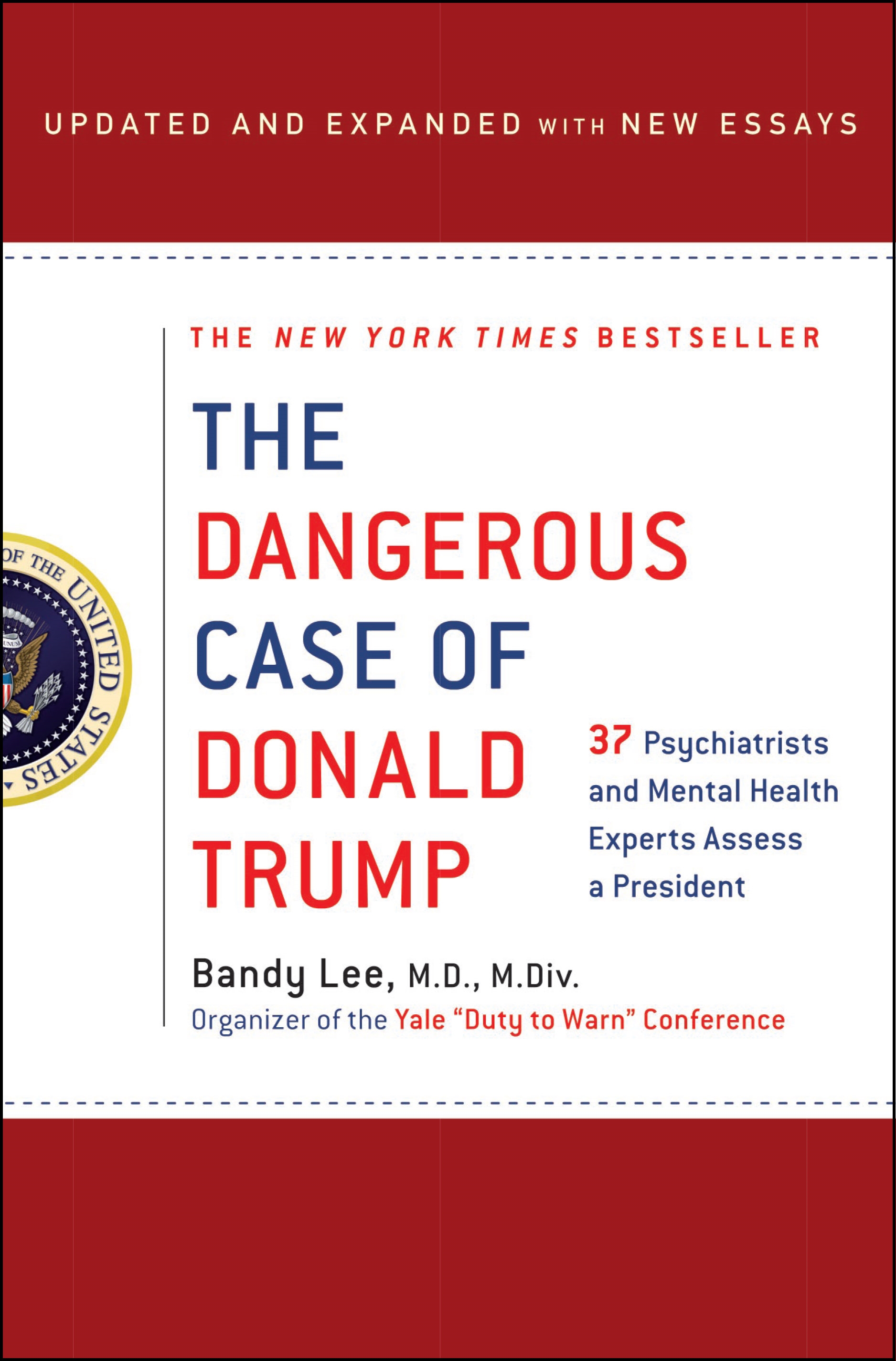
The Dangerous Case of Donald Trump As this bestseller predicted, Trump has only grown more erratic and dangerous as the pressures on him mount. This new edition includes new essays bringing the book up to date—because this is still not normal. Originally released in fall 2017, The Dangerous Case of Donald Trump was a runaway bestseller. Alarmed Americans and international onlookers wanted to know: What is wrong with him? That question still plagues us. The Trump administration has proven as chaotic and destructive as its opponents feared, and the man at the center of it all remains a cipher. Constrained by the APA’s “Goldwater rule,†which inhibits mental health professionals from diagnosing public figures they have not personally examined, many of those qualified to weigh in on the issue have shied away from discussing it at all. The public has thus been left to wonder whether he is mad, bad, or both. The prestigious mental health experts who have contributed to the revised and updated version of The Dangerous Case of Donald Trump argue that their moral and civic "duty to warn" supersedes professional neutrality. Whatever affects him, affects the nation: From the trauma people have experienced under the Trump administration to the cult-like characteristics of his followers, he has created unprecedented mental health consequences across our nation and beyond. With eight new essays (about one hundred pages of new material), this edition will cover the dangerous ramifications of Trump's unnatural state. It’s not all in our heads. It’s in his. POLITICAL SCIENCE,Commentary & Opinion

Fighting for the Dream RW Johnson’s bestselling book How Long Will South Africa Survive? was described by Alec Hogg as ‘a masterpiece in unblemished reality’. Published at the height of the Zuma presidency it offered a chilling warning: the ANC appeared determined to drive South Africa into the abyss. Since then, Cyril Ramaphosa has taken over as president and there have been some attempts to clean up government. But the brief period of ‘Ramaphoria’ is over and the threat to both the economy and the dream of a non-racial democracy is as real as ever. As national elections loom, Johnson examines the state of the nation with pinpoint accuracy. On the one hand state-owned institutions are near collapse, municipalities are defunct and civil strife is rampant. On the other, Ramaphosa and his team have come up with a plan to curb corruption and create growth and prosperity. But will it work? Johnson, in trademark style, picks it apart and, while doing so, offers some ideas of what he thinks is required to get us out of this morass. POLITICAL SCIENCE,Commentary & Opinion

Public Diplomacy New technologies have opened up fresh possibilities for public diplomacy, but this has not erased the importance of history. On the contrary, the lessons of the past seem more relevant than ever, in an age in which communications play an unprecedented role. Whether communications are electronic or hand-delivered, the foundations remain as valid today as they ever have been. Blending history with insights from international relations, communication studies, psychology, and contemporary practice, Cull explores the five core areas of public diplomacy: listening, advocacy, cultural diplomacy, exchanges, and international broadcasting. He unpacks the approaches which have dominated in recent years – nation-branding and partnership – and sets out the foundations for successful global public engagement. Rich with case studies and examples drawn from ancient times through to our own digital age, the book shows the true capabilities and limits of emerging platforms and technologies, as well as drawing on lessons from the past which can empower us and help us to shape the future. This comprehensive and accessible introduction is essential reading for students, scholars, and practitioners, as well as anyone interested in understanding or mobilizing global public opinion. POLITICAL SCIENCE,Commentary & Opinion

The Case for the Green New Deal What is the Green New Deal and how can we afford it? To protect the future of life on earth, we need to do more than just reimagine the economy—we have to change everything. One of the seminal thinkers of the program that helped ignite the US Green New Deal campaign, Ann Pettifor explains how we can afford what we can do, and what we need to do, before it is too late. The Case for the Green New Deal argues that economic change is wholly possible, based on the understanding that finance, the economy and the ecosystem are all tightly bound together. The GND demands total decarbonization and a commitment to an economy based on fairness and social justice. It proposes a radical new understanding of the international monetary system. Pettifor offers a roadmap for financial reform both nationally and globally, taking the economy back from the 1%. This is a radical, urgent manifesto that we must act on now. POLITICAL SCIENCE,Commentary & Opinion

Resistance (At All Costs) Wall Street Journal columnist and New York Times bestselling author Kim Strassel argues that the all-out "Resistance" has become dangerously reckless in its obstruction of President Trump. Among the most consistent and aggressive criticisms of Donald Trump is that he is a threat to American democracy -- a human wrecking ball demolishing our most basic values and institutions. Resistance (At All Costs) makes the opposite case -- that it is Trump's critics, in their zeal to oppose the president, who are undermining our foundations. From the FBI's unprecedented counterintelligence investigation into the Trump campaign, to bureaucratic sabotage, to media partisanship, to the drive-by character assassination of Trump nominee Brett Kavanaugh, the president's foes have thrown aside norms, due process and the rule of law. Resistance (At All Costs) shows that the reaction to Trump will prove far more consequential and damaging to our nation long-term than Trump's time in office. Instant New York Times bestseller. POLITICAL SCIENCE,Commentary & Opinion

No, You Shut Up “Symone’s honest and profound reflection on standing up and speaking out is sure to inspire young people across the country to become the change agents the world needs.†— Congresswoman Maxine Waters In this rousing call to leadership, the self-described millennial spokesperson for the culture, CNN’s designated "woke AF" former commentator, and the youngest national press secretary in the history of the United States shares her take-no-prisoners approach to life, politics, and career success, and shows a new generation how to be loud and powerful in their own right. Many people—most notably white older men—may try to stop Symone Sanders from speaking up and out. But Symone will NOT shut up. And neither should you. In this inspiring call-to-action, Symone tells stories from her own life of not-shutting-up alongside loud young revolutionaries who came before her to help you find your authentic voice and use it to your advantage; to fight ideological battles more effectively; and to resist those who try to silence you. We are all gurus, masterminds, artists, entrepreneurs—we are the change agents we have been waiting for. IT IS US. And the time is RIGHT NOW. I know you’re wondering, “But HOW?†And we don’t have all the answers! Symone is the first to admit we’re all winging it in one way or another. But the point is we’re out there doing it. So get started. Open your mouth and start talking. Loudly. No You Shut Up goes beyond the surplus of “Vote-Or-Die†books we’ve seen before. Because change doesn’t just happen at the ballot box. We need people fighting oppression, injustice, and inequality—in the workplace, on the cultural battlefield, in government, in every corner of the world. With spirited storytelling filtered through a voice that cannot and will not be ignored, Symone inspires you to start now. You don’t need to have all the answers, or wait your turn to help create the change you want to see. All you need is a new toolbox, an unshakable commitment, and the confidence and guidance to wield those tools effectively. POLITICAL SCIENCE,Commentary & Opinion

Give Them an Argument The left must learn to argue. POLITICAL SCIENCE,Commentary & Opinion

A Planet to Win In the twenty-first century, all politics are climate politics. The age of climate gradualism is over, as unprecedented disasters are exacerbated by inequalities of race and class. We need profound, radical change. A Green New Deal can tackle the climate emergency and rampant inequality at the same time. Cutting carbon emissions while winning immediate gains for the many is the only way to build a movement strong enough to defeat big oil, big business, and the super-rich—starting right now. A Planet to Win explores the political potential and concrete first steps of a Green New Deal. It calls for dismantling the fossil fuel industry and building beautiful landscapes of renewable energy, guaranteeing climate-friendly work and no-carbon housing and free public transit. And it shows how a Green New Deal in the United States can strengthen climate justice movements worldwide. We don’t make politics under conditions of our own choosing, and no one would choose this crisis. But crises also present opportunities. We stand on the brink of disaster—but also at the cusp of wondrous, transformative change. POLITICAL SCIENCE,Commentary & Opinion

American Crusade Join the political and cultural fight for America's freedom -- and learn how to protect our nation from the leftist agenda -- with this essential guide from Fox & Friends Weekend co-host Pete Hegseth. In American Crusade, Pete Hegseth explores whether the election of President Donald J. Trump was sign of a national rebirth, or instead the final act of a nation that has surrendered to Leftists who demand socialism, globalism, secularism, and politically-correct elitism. Can real America still win? And how? Hegseth is an old-school patriot who is on a mission to do his part to save our Republic. This book celebrates all that America stands for, while motivating and mustering fellow patriots to stand ready to defend -- and save -- our great country. As he travels around the country talking to American citizens from all walks of life, Hegseth reveals the common wisdom of average Americans -- and how ready they are to join the cultural battlefield. Now is that time, and Hegseth has written the playbook. American Crusade is written with the same insight, politically incorrect candor, and humor that has made his television show one of the most highly-rated in America. POLITICAL SCIENCE,Commentary & Opinion
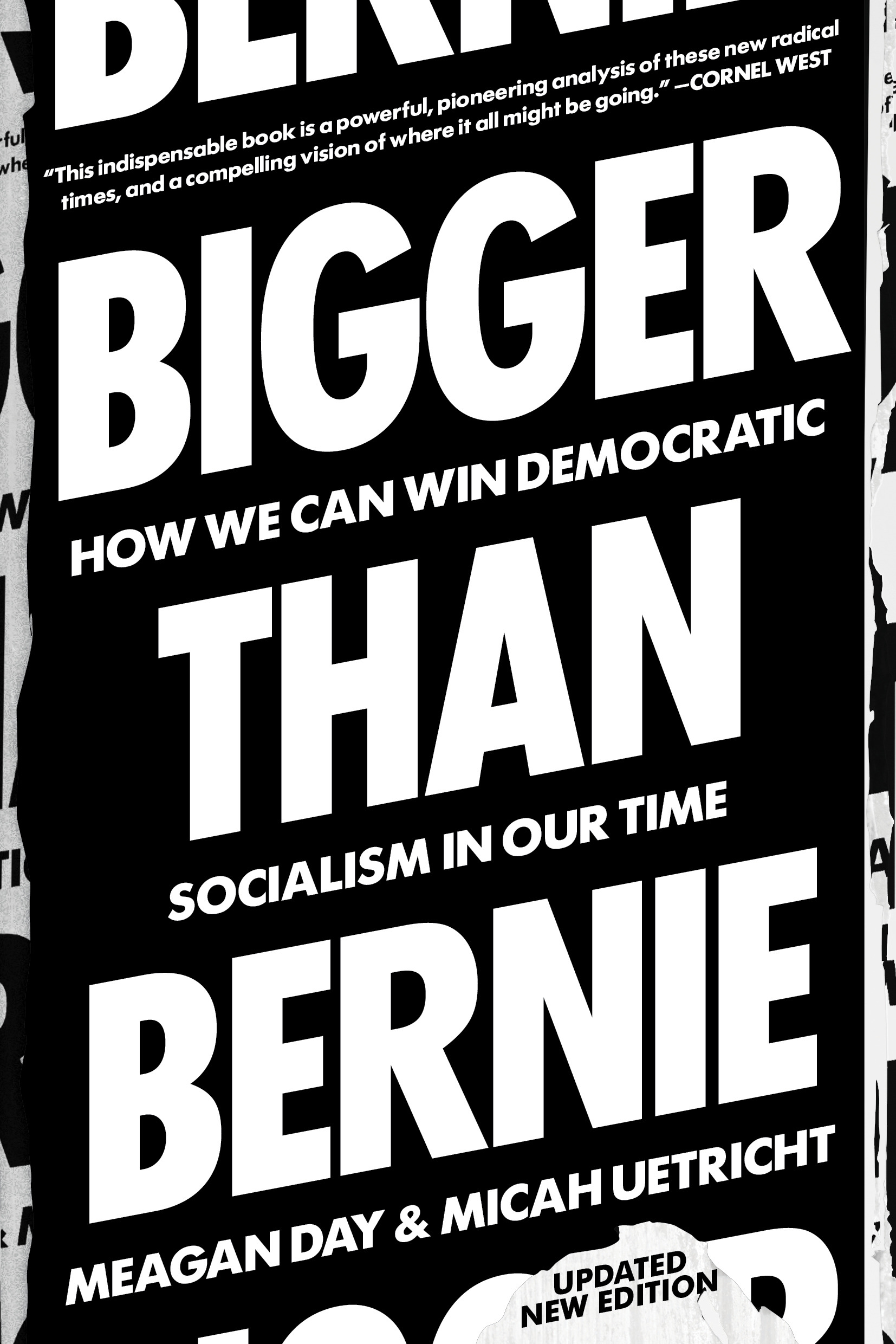
Bigger Than Bernie Win or lose, Bernie has reshaped the landscape of American politics. Where does the political revolution go next? The political ambitions of the movement behind Bernie Sanders have never been limited to winning the White House. Since Bernie first entered the presidential primaries in 2016, his supporters have worked to organize a revolution intended to encourage the active participation of millions of ordinary people in political life. That revolution is already underway, as evidenced by the massive growth of the Democratic Socialists of America, the teachers Bernie motivated to lead strikes across red and blue states, and the rising new generation of radicals in Congress—led by Alexandria Ocasio-Cortez and Ilhan Omar—inspired by his example. In Bigger than Bernie, activist writers Meagan Day and Micah Uetricht give us an intimate map of this emerging movement to remake American politics top to bottom, profiling the grassroots organizers who are building something bigger, and more ambitious, than the career of any one candidate. As participants themselves, Day and Uetricht provide a serious analysis of the prospects for long-term change, offering a strategy for making “political revolution” more than just a campaign slogan. They provide a road map for how to entrench democratic socialism in the halls of power and in our own lives. Bigger than Bernie offers unmatched insights into the people behind the most unique campaign in modern American history and a clear-eyed sense of how the movement can sustain itself for the long haul. POLITICAL SCIENCE,Commentary & Opinion

The Choice For fifty years the abortion debate has remained stagnant, trapped in sterile categories and familiar rhetoric. Each side thinks they know what the other has to say, so they don't listen. Consequently, they have become deaf to each other's pleas. Danielle D'Souza Gill, in a pathbreaking new book, blows the lid off the abortion debate, which is radically different than it was when the Supreme Court issued its landmark ruling of Roe v. Wade in 1973. Technology has transformed the landscape and allowed people to see development in the womb. Ultrasound has rendered many old assumptions about abortion obsolete. The Democratic Left has become radicalized on abortion. It is no longer a necessary evil, but a positive good. Consequently, the Left has legitimized a form of mass killing in this country that dwarfs the deaths caused by cancer, smoking, homicide, terrorism, and war. Writing with freshness, intelligence, and insight, Danielle explores the contours of the debate, taking into account new ideas, new technology, and new laws and putting forth a new vision for a life-affirming society. In Socratic style, Danielle builds her case in response to the strongest contentions of the pro-choice camp. She engages their most powerful arguments head-on, carefully examines them, and then dismantles them. The result is a pro-life argument so persuasive that it will reach into the heart of the most hardened opponent. While it is a heartbreaking book, it is in the end inspiring. No matter what you believe about abortion, this book will educate, astonish, and deeply move you. It may move you to a position different from what you now hold. If you read one book about abortion, make it this one, The Choice: The Abortion Divide in America. POLITICAL SCIENCE,Commentary & Opinion

Front Row at the Trump Show *The Instant New York Time s Bestseller* An account like no other from the White House reporter who has known President Donald Trump for more than 25 years. We have never seen a president like this...norm-breaking, rule-busting, dangerously reckless to some and an overdue force for change to others. One thing is clear: We are witnessing the reshaping of the presidency. Jonathan Karl brings us into the White House in a powerful book unlike any other on the Trump administration. He’s known and covered Donald Trump longer than any other White House reporter. With extraordinary access to Trump during the campaign and at 1600 Pennsylvania Avenue, Karl delivers essential new reporting and surprising insights. These are the behind-the-scenes moments that define Trump’s presidency--an extraordinary look at the president, the person, and those closest to him. This is the real story of Trump’s unlikely rise; of the struggles and battles of those who work in the administration and those who report on it; of the plots and schemes of a senior staff enduring stunning and unprecedented unpredictability. Karl takes us from a TV set turned campaign office to the strange quiet of Trump’s White House on Inauguration Day to a high-powered reelection campaign set to change the country’s course. He shows us an administration rewriting the role of the president on the fly and a press corps that has never been more vital. Above all, this book is only possible because of the surprisingly open relationship Donald Trump has had with Jonathan Karl, a reporter he has praised, fought, and branded an enemy of the people. This is Front Row at the Trump Show. POLITICAL SCIENCE,Commentary & Opinion
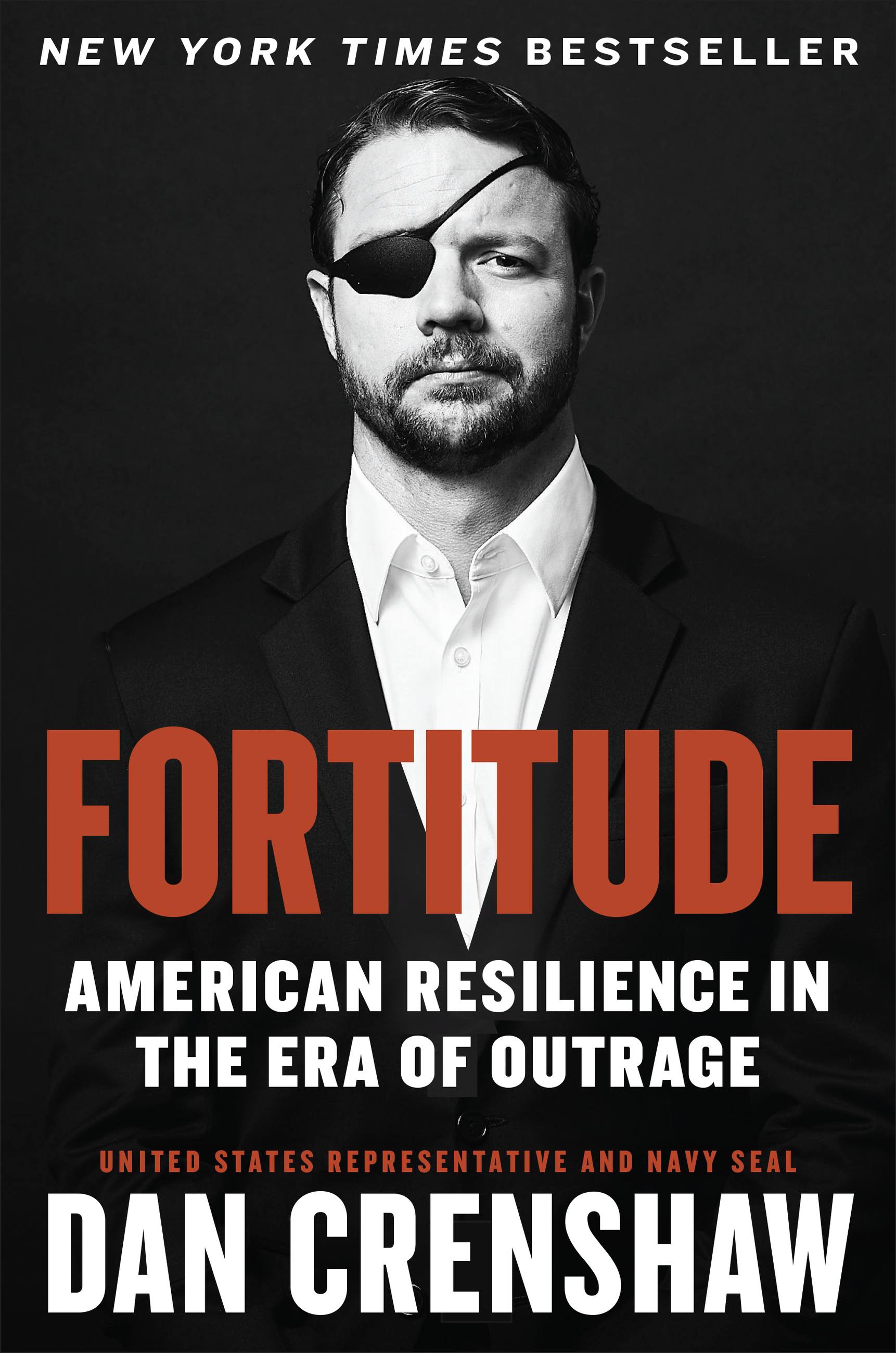
Fortitude Jordan Peterson's Twelve Rules for Life meets Jocko Willink and Leif Babin's Extreme Ownership in this tough-love leadership book from a Navy SEAL and rising star in Republican politics. In 2012, on his third tour of duty, an improvised explosive device left Dan Crenshaw's right eye destroyed and his left blinded. Only through the careful hand of his surgeons, and what doctors called a miracle, did Crenshaw's left eye recover partial vision. And yet, he persevered, completing two more deployments. Why? There are certain stories we tell ourselves about the hardships we face -- we can become paralyzed by adversity or we can adapt and overcome. We can be fragile or we can find our fortitude. Crenshaw delivers a set of lessons to help you do just that. Most people's everyday challenges aren't as extreme as surviving combat, and yet our society is more fragile than ever: exploding with outrage, drowning in microaggressions, and devolving into divisive mob politics. The American spirit -- long characterized by grit and fortitude -- is unraveling. We must fix it. That's exactly what Crenshaw accomplishes with FORTITUDE. This book isn't about the problem, it's about the solution. And that solution begins with each and every one of us. We must all lighten up, toughen up, and begin treating our fellow Americans with respect and grace. FORTITUDE is a no-nonsense advice book for finding the strength to deal with everything from menial daily frustrations to truly difficult challenges. More than that, it is a roadmap for a more resilient American culture. With meditations on perseverance, failure, and finding much-needed heroes, the book is the antidote for a prevailing "safety culture" of trigger warnings and safe spaces. Interspersed with lessons from history and psychology is Crenshaw's own story of how an average American kid from the Houston suburbs went from war zones to the halls of Congress -- and managed to navigate his path with a sense of humor and an even greater sense that, no matter what anyone else around us says or does, we are in control of our own destiny. POLITICAL SCIENCE,Commentary & Opinion

Red November A conservative journalist goes behind enemy lines to cover the 2020 Democratic primaries from the inside. The 2020 Democratic primaries were some of the most extreme in the history of the United States. But the show isn't over yet. Socialism is still on the rise, and ideas that used to be considered crazy are now even more mainstream than they were before. In Red November, conservative journalist Joel Pollak tells the story of how the Democratic party got so extreme, and give a riveting account of life on the campaign trail. There are stories from the Democratic debates, interviews with candidates, and scuffles between journalists. Part travelogue, part satire, part memoir, Red November is a factual, yet humorous, look behind-the-scenes at the candidates, activists, and voters as Democrats choose who will take on the sacred task of removing Donald Trump -- "45," as he is known to his haters -- from the White House and ushering in a utopian age of "Medicare for All" and the "Green New Deal." POLITICAL SCIENCE,Commentary & Opinion
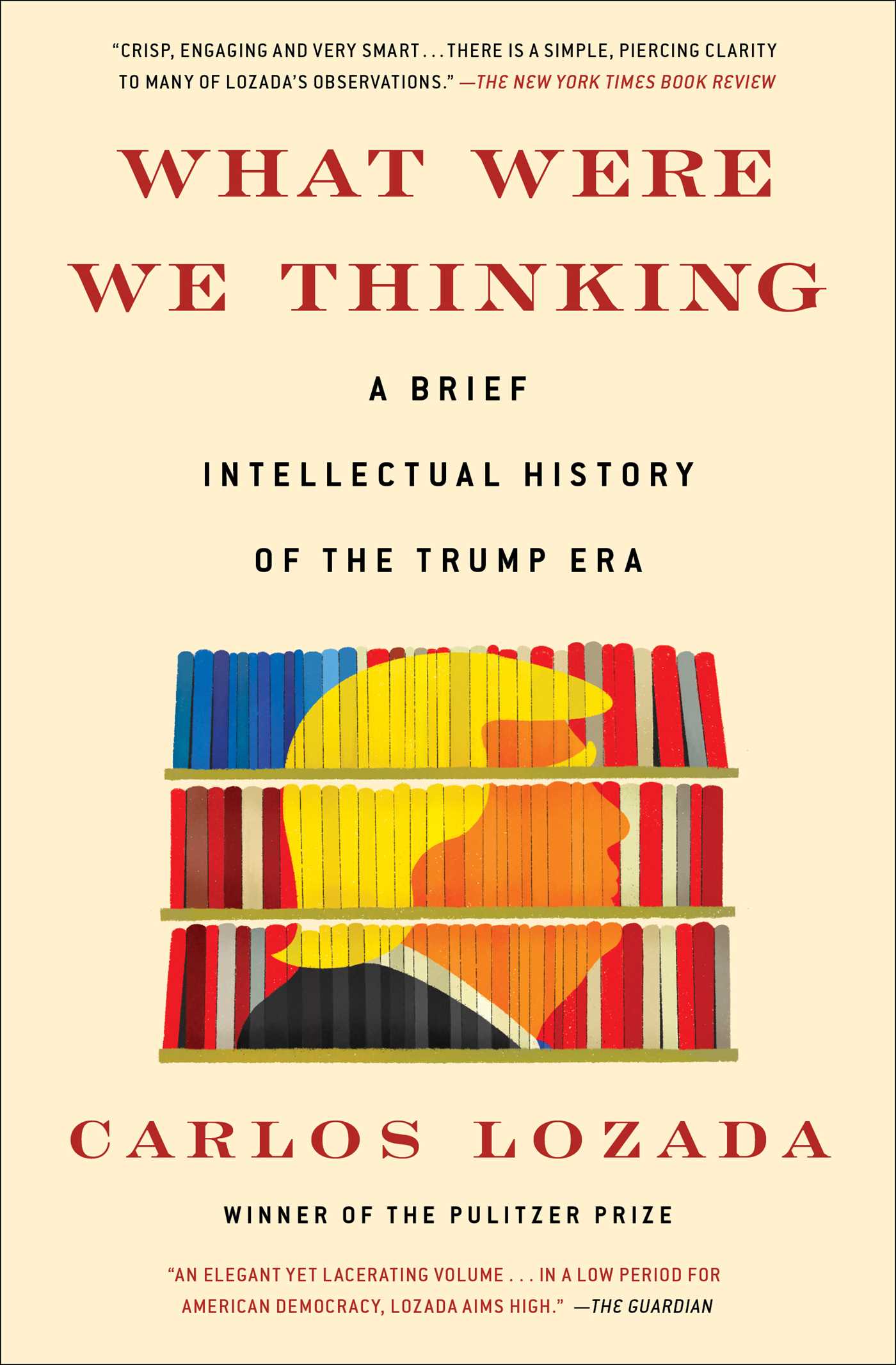
What Were We Thinking The Washington Post ’s Pulitzer Prize–winning book critic uses the books of the Trump era to argue that our response to this presidency reflects the same failures of imagination that made it possible. As a book critic for The Washington Post, Carlos Lozada has read some 150 volumes claiming to diagnose why Trump was elected and what his presidency reveals about our nation. Many of these, he’s found, are more defensive than incisive, more righteous than right. In What Were We Thinking, Lozada uses these books to tell the story of how we understand ourselves in the Trump era, using as his main characters the political ideas and debates at play in America today. He dissects works on the white working class like Hillbilly Elegy; manifestos from the anti-Trump resistance like On Tyranny and No Is Not Enough; books on race, gender, and identity like How to Be an Antiracist and Good and Mad; polemics on the future of the conservative movement like The Corrosion of Conservatism; and of course plenty of books about Trump himself. Lozada’s argument is provocative: that many of these books—whether written by liberals or conservatives, activists or academics, Trump’s true believers or his harshest critics—are vulnerable to the same blind spots, resentments, and failures that gave us his presidency. But Lozada also highlights the books that succeed in illuminating how America is changing in the 21st century. What Were We Thinking is an intellectual history of the Trump era in real time, helping us transcend the battles of the moment and see ourselves for who we really are. POLITICAL SCIENCE,Commentary & Opinion
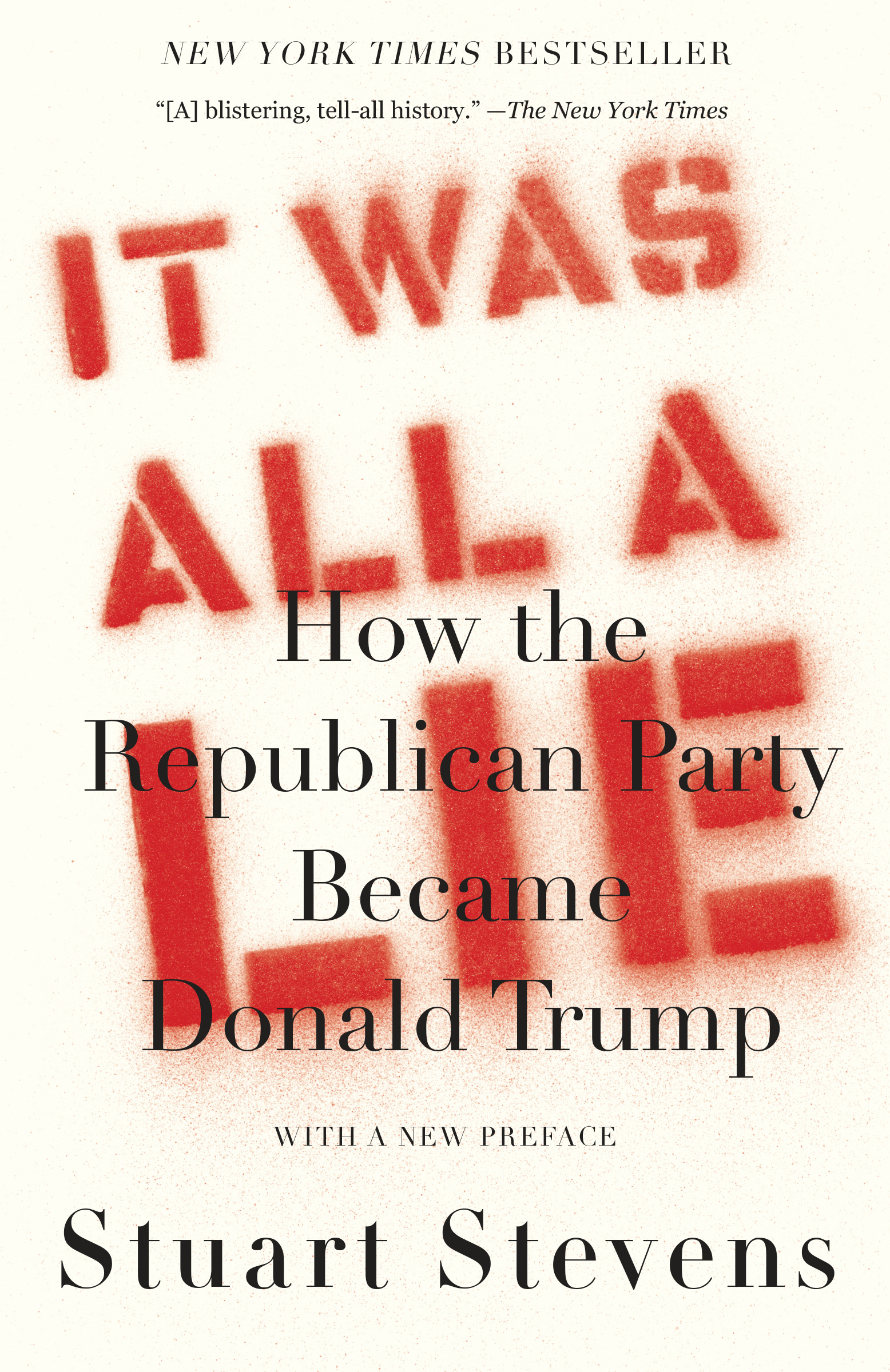
It Was All a Lie AN INSTANT NEW YORK TIMES BESTSELLER "In his bare-knuckles account, Stevens confesses to the reader that the entire apparatus of his Republican Party is built on a pack of lies... This reckoning inspired Stevens to publish this blistering, tell-all history... Although this book will be a hard read for any committed conservatives, they would do well to ponder it."--Julian E. Zelizer, The New York Times From the most successful Republican political operative of his generation, a searing, unflinching, and deeply personal exposé of how his party became what it is today Stuart Stevens spent decades electing Republicans at every level, from presidents to senators to local officials. He knows the GOP as intimately as anyone in America, and in this new book he offers a devastating portrait of a party that has lost its moral and political compass. This is not a book about how Donald J. Trump hijacked the Republican Party and changed it into something else. Stevens shows how Trump is in fact the natural outcome of five decades of hypocrisy and self-delusion, dating all the way back to the civil rights legislation of the early 1960s. Stevens shows how racism has always lurked in the modern GOP's DNA, from Goldwater's opposition to desegregation to Ronald Reagan's welfare queens and states' rights rhetoric. He gives an insider's account of the rank hypocrisy of the party's claims to embody "family values," and shows how the party's vaunted commitment to fiscal responsibility has been a charade since the 1980s. When a party stands for nothing, he argues, it is only natural that it will be taken over by the loudest and angriest voices in the room. It Was All a Lie is not just an indictment of the Republican Party, but a candid and often lacerating mea culpa. Stevens is not asking for pity or forgiveness; he is simply telling us what he has seen firsthand. He helped to create the modern party that kneels before a morally bankrupt con man and now he wants nothing more than to see what it has become burned to the ground. POLITICAL SCIENCE,Commentary & Opinion

BLITZ NEW YORK TIMES BESTSELLER WALL STREET JOURNAL BESTSELLER USA TODAY BESTSELLER "'BLITZ , Trump Will Smash the Left and Win', by David Horowitz. Amazon #1 Bestseller. Hot book, great author!" — President Donald J. Trump BUCKLE UP—2020 WILL BE THE POLITICAL RIDE OF YOUR LIFE! IN NOVEMBER TRUMP WILL SMASH THE LEFT AND WIN! “We love David Horowitz. He thinks Trump is gonna win in a landslide in November, and he gives reasons why in the book, and he says Republicans are gonna be singing 'Happy Days Are Here Again' once November comes and the election is over and the votes are counted.†— Rush Limbaugh "He is one of the bravest guys. He found the real intent [of the Left] was to control America. He has never, ever sat down. A true national treasure.†— Glenn Beck “If you’re interested in debating deranged liberals with facts, you won’t want to miss this latest book.†— Donald Trump, Jr. “ BLITZ is a MUST-read for those who want to better understand what is really happening in the ‘idea war’ for the soul of America.†— Governor Mike Huckabee BLITZ reveals the attacks made against Trump have been the most brutal ever mounted against a sitting president of the United States. Blinded by deep-seated hatred of his person and his policies, the left even desperately tried to oust Trump in a failed impeachment bid. Horowitz shows that their very attacks—targeting a man whose mission has been to “Drain the Swamp†and “Make America Great Again†backfired, turning Trump himself into a near martyrwhile igniting the fervor of his “base.†With the 2020 election upon us, New York Times bestselling author David Horowitz chronicles the brutal battles, bitter backlash, and leftwing lies Trump has faced as Democrats repeatedly try to sabotage his presidency. You’ll discover the left’s terrifying socialist and, in some cases, communist agendas as you’ve never seen them before. Trump’s response? In the meantime, he’s going to steamroll this opposition in November using the same playbook he has used to win before. In BLITZ you will find shocking revelations: The 9 biggest dangers to America the left poses—their agenda will blow your mind. Show me the money: naming the billionaires and fat cats really out to get Trump. How patriotism suddenly became “white nationalism†linking Trump to Hitler and the KKK . The growing secularism of the left and how the hate pushed against Christians will backfire. Why every effort to demonize Trump and his supporters is failing like crazy. Obama’s agenda: how the former president casts a much greater shadow over Trump’s political woes than you ever imagined. The Genius: how Trump’s brilliant strategy has worked and will continue to work, making him president again in 2021! The effort to remove and destroy our duly elected President may be the greatest challenge America has faced since the Civil War, explains Horowitz. For the first time BLITZ exposes the left’s strategy to take down Trump, and how Trump not only beat them at their own game, but how he’s turning the tables on them to achieve a stunning reelection win come November. “An indispensable book— BLITZ — explaining why today’s Democrats are so dangerous and why President Trump is their nemesis.†— Mark R. Levin, New York Times bestselling author of Unfreedom of the Press “ BLITZ is the latest must-read from Horowitz: insightful, hard-hitting, controversial, and uncompromising. Ignore him at your peril.†— Peter Schweizer, New York Times bestselling author of Clinton Cash and Profiles in Corruption “This is the book your anti-Trump relatives and friends should read...as clear a moral indictment of the anti-Trump left as has been written.†— Dennis Prager, President of PragerU and New York Times bestselling author “Unparalleled insight into the current political climate, how we got here and what it means for 2020 elections.†— Sean Spicer, Host of Spicer & Co., Newsmax TV “Horowitz understands the left's malevolent goals and how to stop them. This is a must read-book!†— Charlie Kirk, New York Times bestselling author of The MAGA Doctrine “[David Horowitz] author and political activist believes President Donald Trump should focus on the issue of keeping Americans safe to help secure his re-election in the fall.†– One News Now POLITICAL SCIENCE,Commentary & Opinion

Live Free Or Die #1 New York Times Bestseller America’s top-rated cable news host offers his first book in ten years: a look at America’s fight against those who would reverse our tradition of freedom—a fight we can’t afford to lose in 2020. America is great for a reason. Built on principles of freedom, rugged individualism, and self-sufficiency, no country has ever accumulated more power and wealth, abused it less, or used that power more to advance the human condition. And yet, as America blossomed, leftwing radicalism and resentment festered beneath the surface, threatening to undermine democracy first in the sixties and now—more insidiously than ever—in the form of social justice warriors, the deep state, and compromised institutions like academia and the mainstream media. Our fate if we succumb to a Democratic victory in 2020? A big step toward full-blown socialism along with the economic dysfunction and social strife that are its hallmarks. With radical Democrats demanding the Green New Deal, socialized medicine, abortion on demand, open borders, abolishing the Electoral College, packing the Supreme Court, and an end to free speech, our great nation will be fundamentally transformed beyond recognition. Ronald Reagan once said, “Freedom is but one generation away from extinction,†and his words have never rung truer. In Live Free or Die, Sean demonstrates why now is an All Hands on Deck moment to save the Republic. His solution is simple: if all you can do is vote, then vote. But if you can inform people of the truth, that’s even better. And the truth is that the future of American freedom rests on Donald Trump’s reelection. POLITICAL SCIENCE,Commentary & Opinion
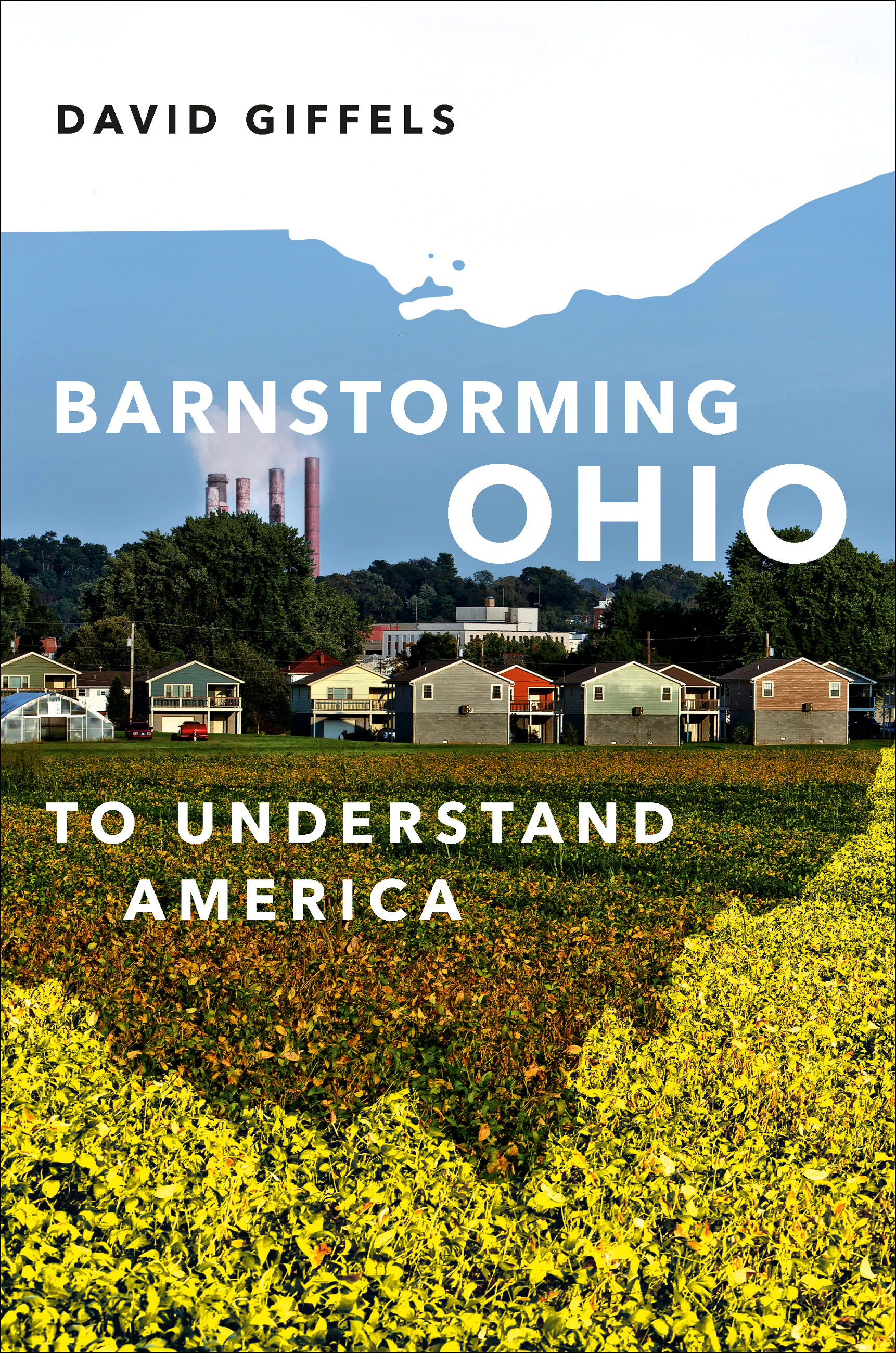
Barnstorming Ohio An on-the-ground look at the diverse challenges facing Ohio, in light of its national significance as the state that has aligned with presidential election winners more than any other -- from an award-winning author and essayist dubbed "the Bard of Akron" (New York Times). The question of America's identity has rarely been more urgent than now, and no American place has ever been more reflective of that identity than Ohio. David Giffels, a lifelong resident of the "bellwether" state, has spent a quarter century writing and thinking about what it means to live in what he calls "an all-American buffet, an uncannily complete everyplace." With Cleveland as the end of the North, Cincinnati as the beginning of the South, Youngstown as the end of the East, and Hicksville (yes, Hicksville) as the beginning of the Midwest, Ohio offers important insight into the state of the nation. As a historic 2020 presidential election approaches, Barnstorming Ohio is Giffels' account of a year on Ohio's roads, visiting people and places that offer valuable reflections of the national questions and concerns, as well as astounding electoral clairvoyance -- since 1896, Ohio has accurately chosen the winner in twenty-nine of thirty-one presidential elections, more than any other state. With lyricism and a native's keen eye, Barnstorming Ohio takes readers into the living room of a man whose life was upended just shy of retirement by General Motors' shutdown of its Lordstown assembly plant. It offers an exclusive view into the presidential campaign of Ohio Democratic hopeful Tim Ryan. It takes us into the sodden soybean fields of farmers struggling to outlast the dual punch of a protracted trade war and historic rainfall, and to an indie rock music festival in Dayton a week after a mass shooting there. We enter the otherworld of long-dormant shopping malls as Amazon transforms them into vast new fulfillment centers. On the lighter side, Giffels makes a "beer run" into Ohio's booming craft brewing industry and revisits the legend (and the bird-nest toupee) of Jim Traficant, a larger-than-life Ohio politician whom many have called the "proto-Trump." In a year when Americans are seeking answers, Barnstorming Ohio offers rare and carefully nuanced access to the people who have always held them. POLITICAL SCIENCE,Commentary & Opinion

Searching for Socialism A new and essential history of the Labour new left from Tony Benn to Jeremy Corbyn. Jeremy Corbyn’s rapid ascent to the leadership of the Labour Party, driven by a groundswell of popular support particularly among the young, was met at the time by a baffled media. Just where did Jeremy Corbyn come from? In Searching for Socialism, Leo Panitch and Colin Leys argue that it is only by understanding Corbyn’s roots in the Bennite Labour New Left’s long struggle to transcend the limits of “parliamentary socialism” and democratise the party, as a precondition for democratising the state, can you understand his surge to become leader of the party. Closely analyzing the forces inside the party aligned against Corbyn’s leadership, Panitch and Leys explain what happened between the validation of the Corbyn project in the 2017 election, while advancing an ambitious programme of democratic socialist measures unmatched anywhere since the 1970s, and the electoral defeat amidst the Brexit conjuncture of 2019. They argue that while this defeat marked the farthest point to which the generation formed in the 1970s was able to carry the Labour new left project, it seems unlikely that the new generation of activists will quickly see any other way forward than continuing the struggle inside the Labour Party, so as to fundamentally change it. In the face of the contradictions being generated by twenty-first-century capitalism, and the need for discovering and developing new political forms adequate to addressing them, this book is required reading for democratic socialists, not just in Britain but everywhere. POLITICAL SCIENCE,Commentary & Opinion
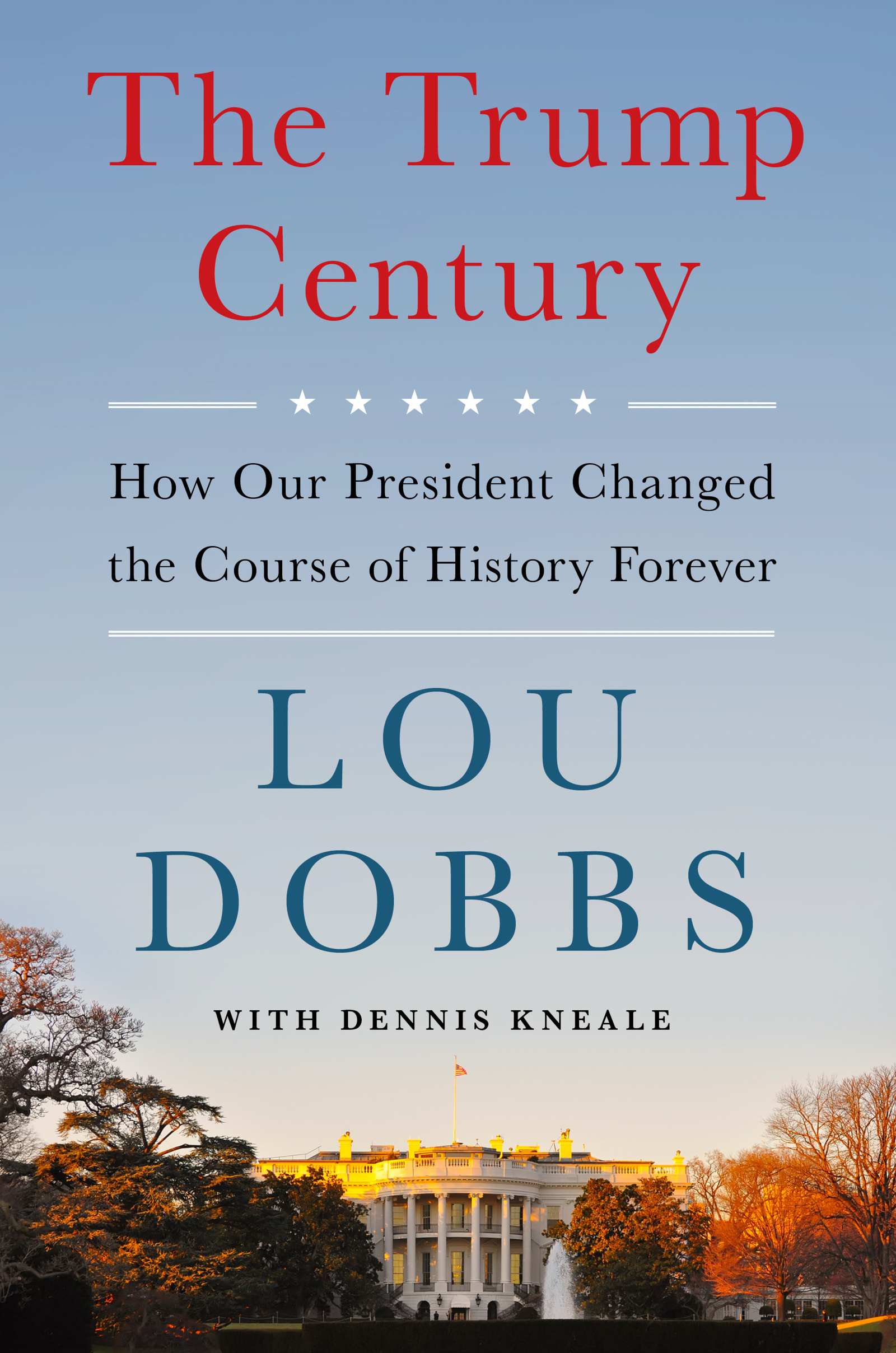
The Trump Century How did Donald Trump almost single-handedly reverse America’s decline? As the 21st Century began, the world’s only superpower was economically adrift, policing the world at the expense of American lives and trillions of dollars, weighed down by one-sided trade and security agreements with Europe and China ratified in a different era. Elites of both political parties battled over who would manage America’s decline from preeminent world power. In The Trump Century, the indomitable Lou Dobbs explains how Trump has steered the debate every day he has been in politics, greatly expanding what Washington thinks is possible. By 2016, the globalist elites demanded no one speak about limiting illegal immigration or securing our borders. The elites told you communist China would soon be like us, and the PC orthodoxy told you what you could or could not say. You were told America’s Middle Class could never grow again and wages would be stagnant into perpetuity. Trump reversed all of that as radical Democrats and the Deep State conspired to overthrow his Presidency, as the deadly pandemic raged, and orchestrated street protests and violent riots dominated news headlines. He has not only made America great again but created a new standard for all future Presidents and likely has set the American agenda for the next hundred years. The Trump Century opens a window into Trump’s thinking on the economy, foreign policy, and border security and will energize his allies when they realize the future they’ve shaped. POLITICAL SCIENCE,Commentary & Opinion
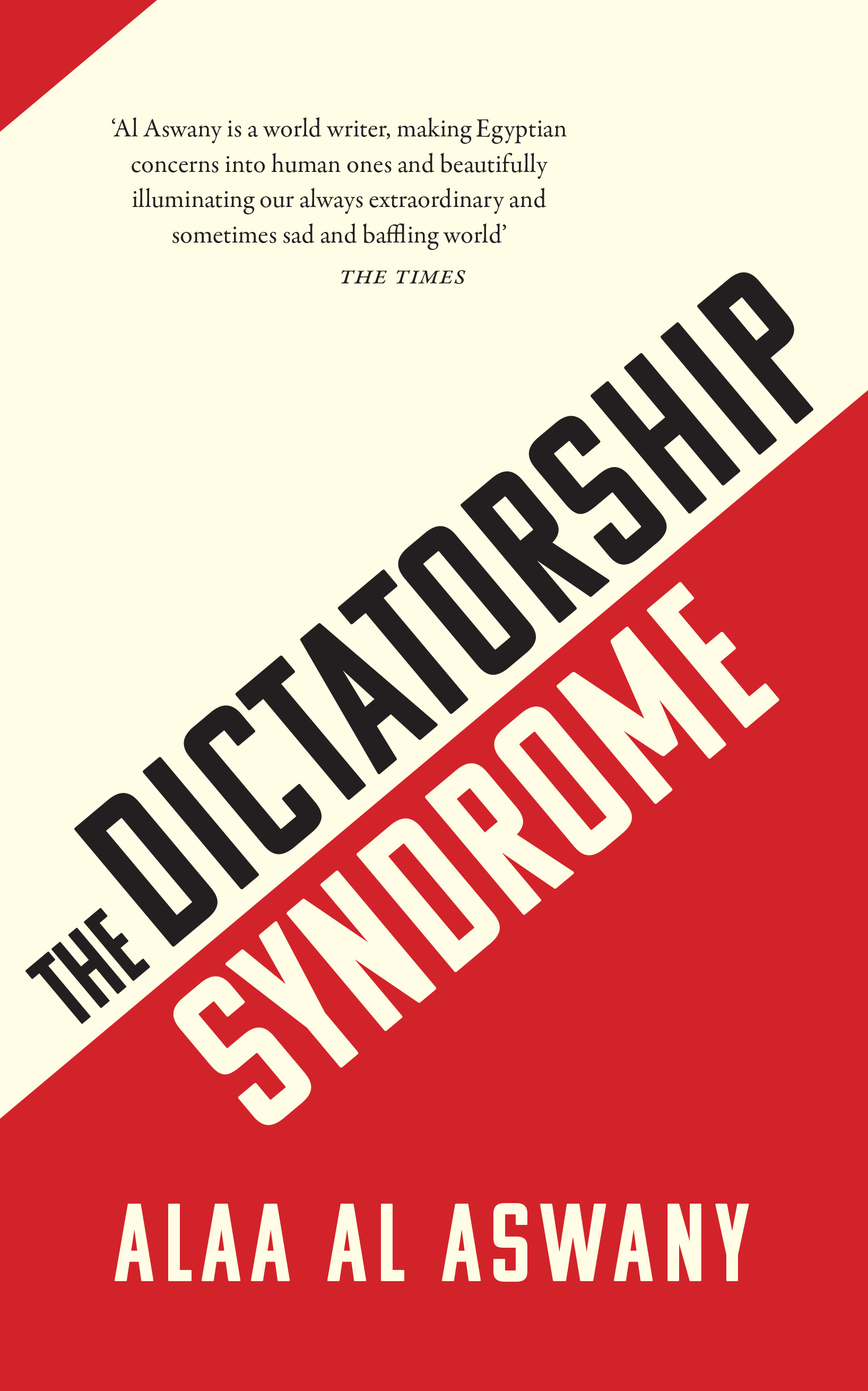
The Dictatorship Syndrome The study of dictatorship in the West has acquired an almost exotic dimension. But authoritarian regimes remain a painful reality for billions of people worldwide who still live under them, their freedoms violated and their rights abused. They are subject to arbitrary arrest, torture, corruption, ignorance, and injustice. What is the nature of dictatorship? How does it take hold? In what conditions and circumstances is it permitted to thrive? And how do dictators retain power, even when reviled and mocked by those they govern? In this deeply considered and at times provocative short work, Alaa Al Aswany tells us that, as with any disease, to understand the syndrome of dictatorship we must first consider the circumstances of its emergence, along with the symptoms and complications it causes in both the people and the dictator. POLITICAL SCIENCE,Commentary & Opinion
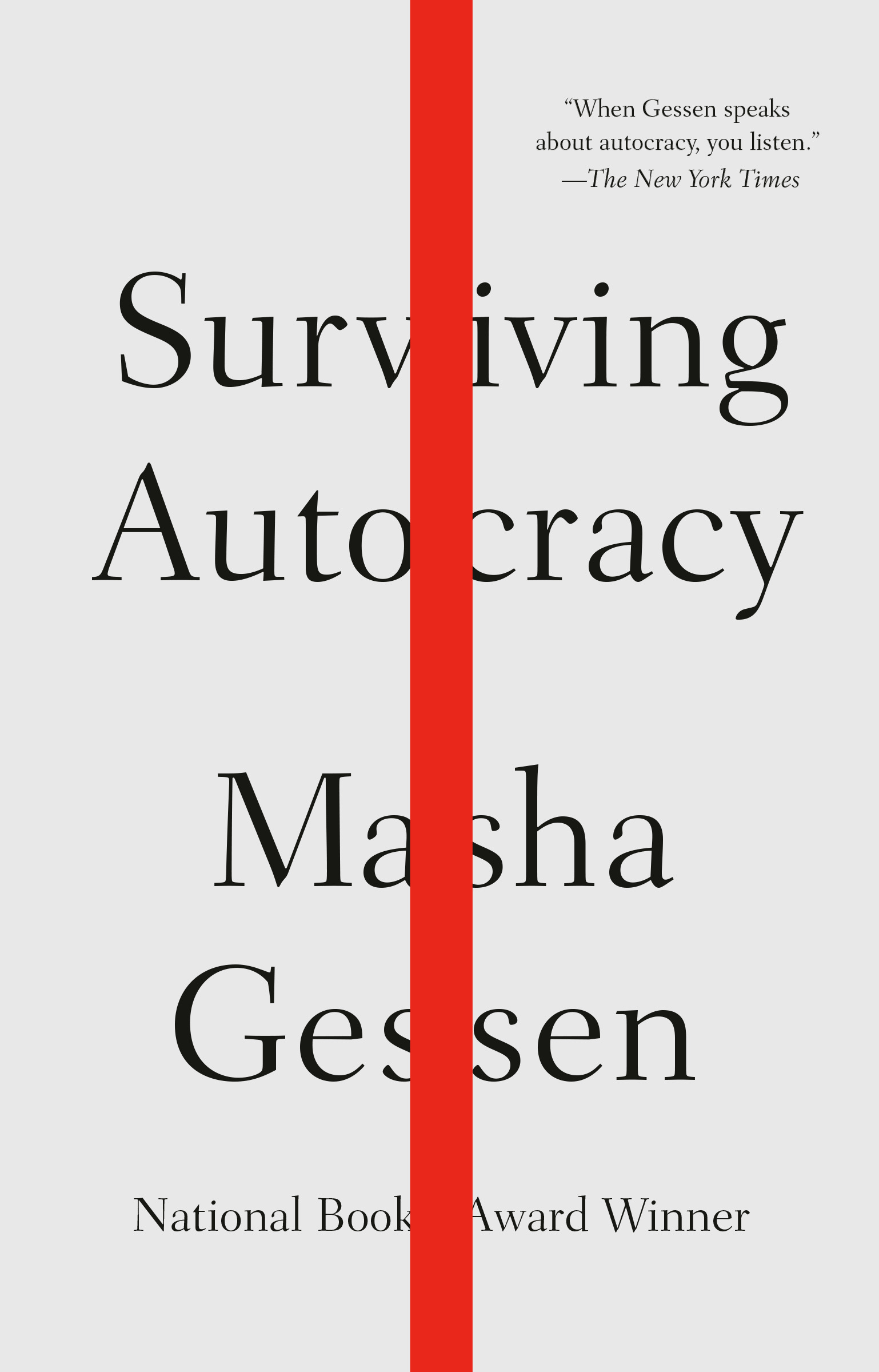
Surviving Autocracy “When Gessen speaks about autocracy, you listen.” — The New York Times “The Platonic ideal of the anti-Trump Trump book.” —The Washington Post As seen on MSNBC’s Morning Joe and heard on NPR’s All Things Considered: the bestselling, National Book Award–winning journalist offers an essential guide to understanding, resisting, and recovering from the ravages of our tumultuous times. In the run-up to the 2016 election, Masha Gessen stood out from other journalists for the ability to convey the ominous significance of Donald Trump’s speech and behavior, unprecedented in a national candidate. Within forty-eight hours of his victory, the essay “Autocracy: Rules for Survival” had gone viral, and Gessen’s coverage of Trump’s norm-smashing presidency became essential reading for a citizenry struggling to wrap their heads around the unimaginable. Thanks to the special perspective that is the legacy of a Soviet childhood and two decades covering the resurgence of totalitarianism in Russia, Gessen has a sixth sense for signs of autocracy—and the unique cross-cultural fluency to delineate its emergence to Americans. This incisive book provides an indispensable overview of the calamitous trajectory of the past few years. Gessen not only highlights the corrosion of the media, the judiciary, and the cultural norms we hoped would save us but also tells us the story of how a short few years have changed us from a people who saw ourselves as a nation of immigrants to a populace haggling over a border wall, heirs to a degraded sense of truth, meaning, and possibility. Surviving Autocracy is an inventory of ravages but also a beacon to recovery—or to enduring, and resisting, an ongoing assault. POLITICAL SCIENCE,Commentary & Opinion

Guns, An American Conversation Based on an article by Pulitzer Prize–winning reporters, the fascinating results of an important nationwide conversation about guns: Can complete strangers representing every point along the political divide engage in civil and productive discourse on the topic of gun control? As Americans, we spend a lot of time talking about guns. We have arguments, protests, declarations, and slogans about what kind of weapons can be sold and to whom. But the one thing we rarely have when it comes to firearms is a real conversation, and not just with members of our own tribe, but with people whose ideas don’t align with ours. That is perhaps why the country is so divided when it comes to reducing gun violence. Guns, an American Conversation follows up on a handful of strangers—teachers and gun-rights advocates, hunters and police officers, mothers and fathers across the United States—brought together in a larger group of 150 people, for a month-long moderated Facebook group chat. The goal of the project—which expanded on earlier efforts—was to foster a civil, yet honest, dialogue between people whose backgrounds and beliefs led them to have opposing views on the issue. Not just a journalistic account, Guns attempts to map out common territory in a nation driven by profound divides. It includes sidebars, charts, and graphics that list additional information about gun control in the United States and provide the reader with tools to continue the discussion in their own lives. This book might not change your mind about gun control, but it will help you learn to cross divides in conversation. POLITICAL SCIENCE,Commentary & Opinion

Leading America The former White House Press Secretary and Communications Director analyzes our current political moment through the lens of politics and culture and argues that President Trump has put the country back on the right track and needs to be reelected in 2020. When it was announced that Sean Spicer would be the newest guest on ABC's Dancing with the Stars, he was promptly attacked by countless liberal media institutions. Apparently, they'd rather see him crawl under a rock forever than have a little fun on television (while raising money for charity). And that was only a small example. All over the country, liberals are attacking conservatives with the kind of fervor once reserved for hardened criminals. It's a zero sum game -- either you're with them one hundred percent, or you're the enemy. Whether you're in politics, media, academia, or entertainment, it's the same story. As one of the few people who's played a small part in all of those worlds, Sean Spicer has a unique perspective on the methods used by the left to shut down conservative voices. He's been parodied on SNL, ripped apart on the nightly news, and protested on college campuses, all for doing his job. Outside of the left's bubble, however, he's been able to transition from politics to entertainment very well, and he's got huge numbers of supporters. In Leading America, he writes about all the ways President Trump has fought back against the Left, and examines all the ways conservatives can take a stand to uphold their rights and values. POLITICAL SCIENCE,Commentary & Opinion
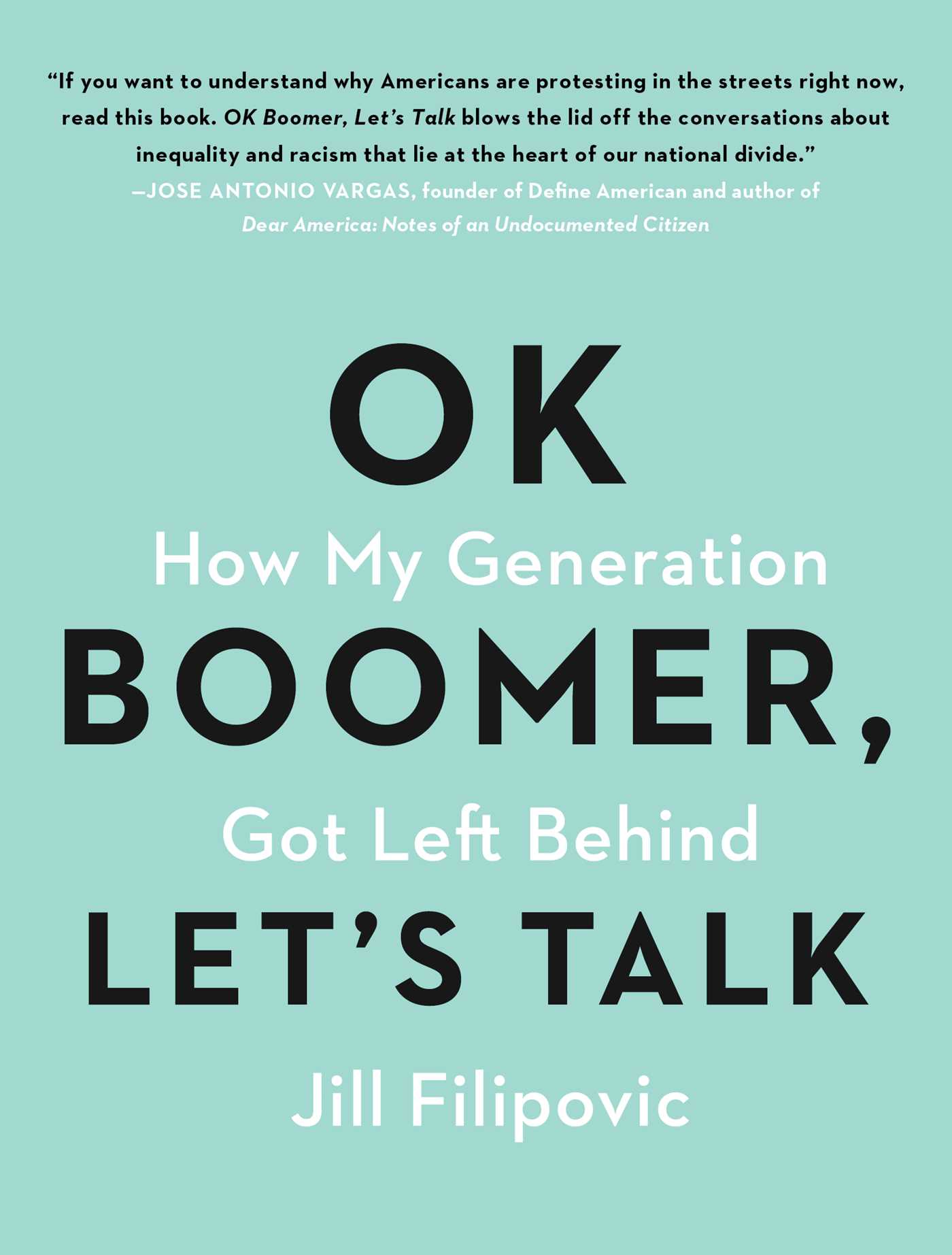
OK Boomer, Let's Talk “Particularly relevant in an election year...This book is full of data—on the economy, technology, and more—that will help millennials articulate their generational rage and help boomers understand where they’re coming from.†—The Washington Post “Jill Filipovic cuts through the noise with characteristic clarity and nuance. Behind the meme is a thoughtfully reported book that greatly contributes to our understanding of generational change.†—Irin Carmon, coauthor of the New York Times bestseller Notorious RBG Baby Boomers are the most prosperous generation in American history, but their kids are screwed. In this eye-opening book, journalist Jill Filipovic breaks down the massive problems facing Millennials including climate, money, housing, and healthcare. In Ok Boomer, Let’s Talk, journalist (and Millenial) Jill Filipovic tells the definitive story of her generation. Talking to gig workers, economists, policy makers, and dozens of struggling Millennials drowning in debt on a planet quite literally in flames, Filipovic paints a shocking and nuanced portrait of a generation being left behind: -Millennials are the most educated generation in American history—and also the most broke. -Millennials hold just 3 percent of American wealth. When they were the same age, Boomers held 21 percent. -The average older Millennial has $15,000 in student loan debt. The average Boomer at the same age? Just $2,300 in today’s dollars. -Millennials are paying almost 40 percent more for their first homes than Boomers did. -American families spend twice as much on healthcare now than they did when Boomers were young parents. Filipovic shows that Millennials are not the avocado-toast-eating snowflakes of Boomer outrage fantasies. But they are the first American generation that will do worse than their parents. “OK, Boomer†isn’t just a sarcastic dismissal—it’s a recognition that Millennials are in crisis, and that Boomer voters, bankers, and policy makers are responsible. Filipovic goes beyond the meme, upending dated assumptions with revelatory data and revealing portraits of young people delaying adulthood to pay down debt, obsessed with “wellness†because they can’t afford real healthcare, and struggling to #hustle in the precarious gig economy. Ok Boomer, Let’s Talk is at once an explainer and an extended olive branch that will finally allow these two generations to truly understand each other. POLITICAL SCIENCE,Commentary & Opinion

Optimism over Despair “From meditations on human nature to strategic advice for the Trump era, Chomsky remains the thinker who shaped a generation, a beacon of hope†(Sarah Jaffe, host of Belabored) This volume offers readers a concise and accessible introduction to the ideas of Noam Chomsky, described by the New York Time as “arguably the most important intellectual alive.†In these recent, wide-ranging interviews, conducted for Truthout by C. J. Polychroniou, Chomsky discusses his views on the “war on terror†and the rise of neoliberalism, the refugee crisis and cracks in the European Union, prospects for a just peace in Israel/Palestine, the rise of the Black Lives Matter movement, the dysfunctional US electoral system, the grave danger posed to humanity by the climate crisis, and the hopes, prospects, and challenges of building a movement for radical change. “A must read in these troubling times . . . This is an excellent collection of interviews that highlights Chomsky’s encyclopedic knowledge of the key issues of our day and his unwavering criticism of the regime of the global 1%.†—Deepa Kumar, author of Islamophobia and the Politics of Empire “In this brilliant series of recent and wide-ranging interviews, Noam Chomsky combines an astounding breadth of knowledge, great depth of insight, clarity in explaining his ideas, and a relentless commitment to social and economic justice. The full package is simply exhilarating, especially in our current dismal era of Donald Trump. Optimism over Despair is a book to devour.†—Robert Pollin, distinguished professor of Economics and codirector of the Political Economy Research Institute “Especially valuable in helping us navigate the dreadful challenges of the Trumpian era.†—Michael Klare, defense correspondent for The Nation POLITICAL SCIENCE,Commentary & Opinion
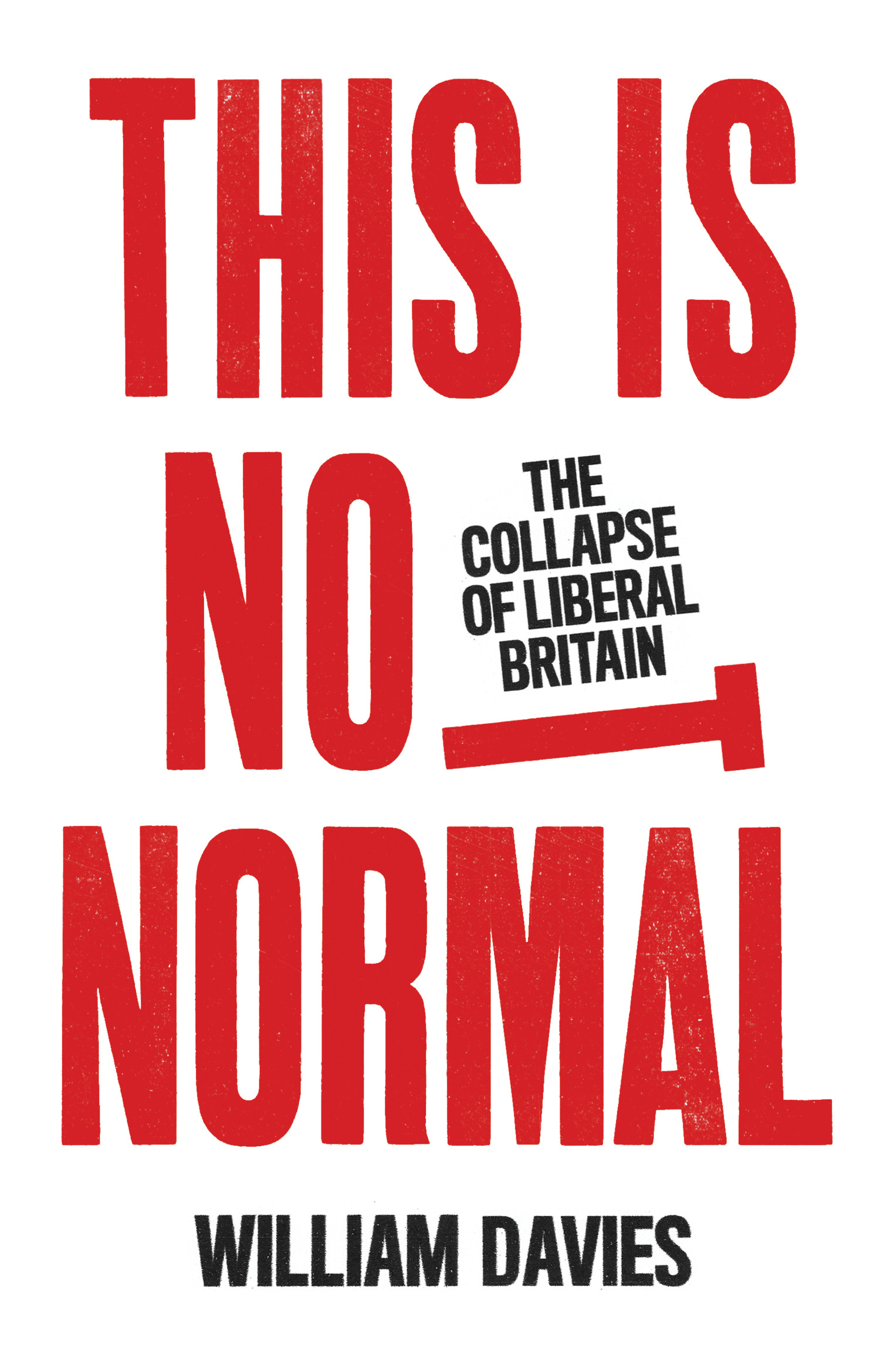
This is Not Normal What just happened and how did we get into this mess? Since 2016, the UK has been in a crisis of its own making: but this is not the fault of Brexit but of a larger problem of our politics. The status of political parties, the mainstream media, public experts and officials have all been disrupted. Along the way, there have been shocking and exhilarating events: the unforeseen 2017 election result, the horrific details of Grenfell Tower and the Windrush scandal, the sudden rise and fall of the Brexit Party.As the 'mainstream' of politics and media has come under attack, the basic norms of public life have been thrown into question. This Is Not Normal takes stock of a historical moment that no longer recognises itself. Davies tells a story of the apparently chaotic and irrational events, and extracts their underlying logic and long-term causes. What we are seeing is the effects of the 2008 financial crash, the failure of the British neoliberal project, the dying of Empire, and the impact of the changes that technology and communications have had on the idea of the public sphere as well as the power of information. This is an essential book for anyone who wants to make sense of this current moment. POLITICAL SCIENCE,Commentary & Opinion

Too Many Times Guns in America have a history. The violence they cause came about from a series of decisions. To reverse them there is a series of solutions. This is your guide to them. Gun violence is a problem with many faces, but seemingly no solution. From mass shootings to deadly domestic abuse to police officers opening fire, it permeates American life. And yet it feels impossible to address. The lines are firmly drawn and the federal government has not passed any legislation to reduce gun ownership in over twenty-five years. That's why it's time to look at the issue differently. In this revelatory collection, gun violence in America is addressed from three angles: how gun violence affects us today, how we have gotten to this juncture legally and socially, and finally, what we can do to reduce and end gun violence in America. Too many lives are lost by gun fire--around 15,000 a year--but we do have the tools to address this crisis. Top journalists, organizations, and anti-gun-violence advocacy groups are represented here--from Pamela Coloff to Ibram X. Kendi to Everytown for Gun Safety and the Giffords Organization--to collect the most comprehensive, thoughtful and practical guide on gun violence in America. There are no deadlocks and no excuses--we have the tools to stop gun violence now. POLITICAL SCIENCE,Commentary & Opinion
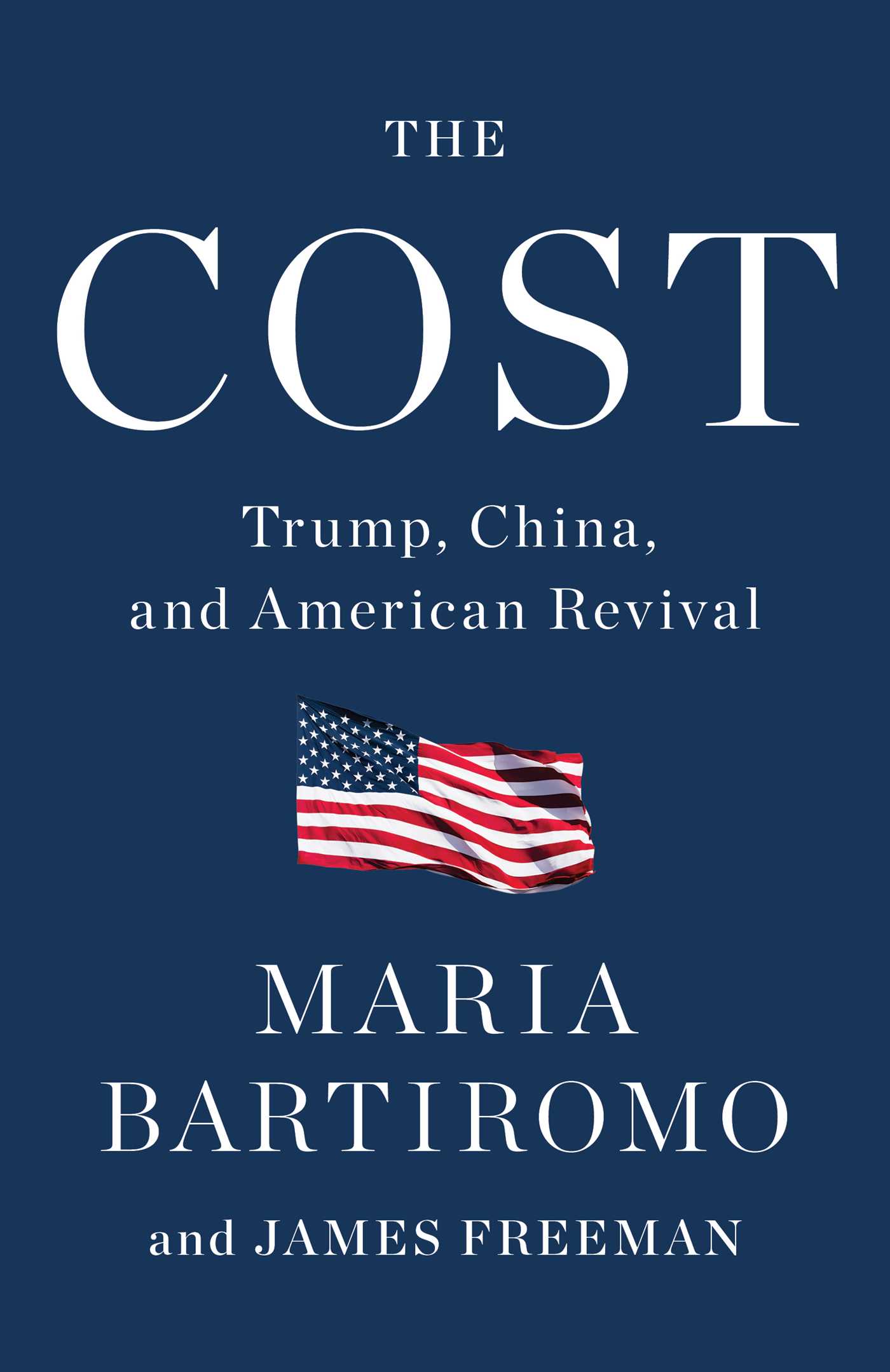
The Cost The world needs a strong America, and America needs an economic revival after the Coronavirus season of shutdowns. Can the playbook that resulted in the greatest job market in history put Americans back to work? From the first moments of his presidency, Donald J. Trump put US economic revival at the top of his agenda. Cutting red tape and slashing business tax rates made companies eager to locate in America again. A surge in corporate investment led to record numbers of US job openings. But there was also another force at work at the start of the Trump era, and it’s impossible to provide a fair accounting of Trump’s governance without noting the unique obstacles he’s faced. The President’s critics styled themselves “The Resistance,†as if they were confronting a tyrant at the head of an invading army rather than their duly elected President. Much of the media establishment regularly—and wrongly—accused him of betraying the country. Most disturbing was the resistance movement inside government, formed even before the 2016 election, which unleashed unprecedented surveillance against Donald Trump. The political and media warfare has never ended. Just as an impeachment case collapsed in the Senate earlier this year, the world was beginning to realize how large a threat the Chinese communist government had become—and what it had been hiding in Wuhan. The destruction caused by the coronavirus is the latest and greatest test for the Trump prosperity agenda. Once again the health and wealth of the world depend on US leadership for economic revival. This is the story of the man US voters chose to lead in 2016 and will soon consider to lead again. POLITICAL SCIENCE,Commentary & Opinion

Don't Lie to Me Judge Jeanine Pirro, author of two New York Times bestsellers, exposes the lies and distortions of the president's enemies. It's been nearly four years since President Trump took office, and Judge Jeanine Pirro has had enough of the left's countless lies and false accusations. She is now forced to ask: How could anyone vote against President Trump this November? What more could you possibly want? In Don't Lie to Me, Judge Jeanine brings her signature writing style and acute legal mind to topics such as the impeachment inquiry, the military, and the road to the 2020 presidential election. She will highlight President Trump's triumphs and his strength during the coronavirus crisis. POLITICAL SCIENCE,Commentary & Opinion

Our Fight for America In the follow-up to the #1 New York Times bestseller Trump's War, Michael Savage makes the case for President Trump in 2020. America rolled into 2020 like a juggernaut, with the strongest economy in its history and a renewed leadership role on the world stage. President Trump was cruising to reelection on the strength of record low unemployment, phase one of a historic trade deal, and a more stable Middle East after the defeat of ISIS. Then, catastrophe struck. A novel coronavirus originating in Wuhan, China, swept the world, taking hundreds of thousands of lives and wreaking economic and social destruction. As America battled to its feet and prepared to reopen its economy, the tragic death of George Floyd at the hands of a police officer lit a powder keg of political tension waiting to explode after months of lockdown. As the November elections approach, America is at war with itself to decide if it will remain a land of freedom and opportunity, or whether a radical new vision will emerge. Americans are searching for answers. Was the American lockdown necessary to defeat Covid-19 or was it a politically motivated strategy to harm President Trump's reelection chances? Does the death of George Floyd represent a systemic problem with American police or is the Left exploiting the tragedy for political purposes? Where does legitimate protest end and insurrection begin? A trained scientist who studied epidemiology for his PhD and one of America's most popular conservative radio hosts for the past twenty-six years, Dr. Michael Savage is uniquely positioned to answer these burning questions. In OUR FIGHT FOR AMERICA: THE WAR CONTINUES, Savage cuts through the propaganda and noise to present a clear analysis of the crises and the political and scientific motivations behind them. Michael Savage tells the truth even when nobody wants to hear it and presents a clear vision of what Americans must do to survive our most turbulent period in decades. POLITICAL SCIENCE,Commentary & Opinion
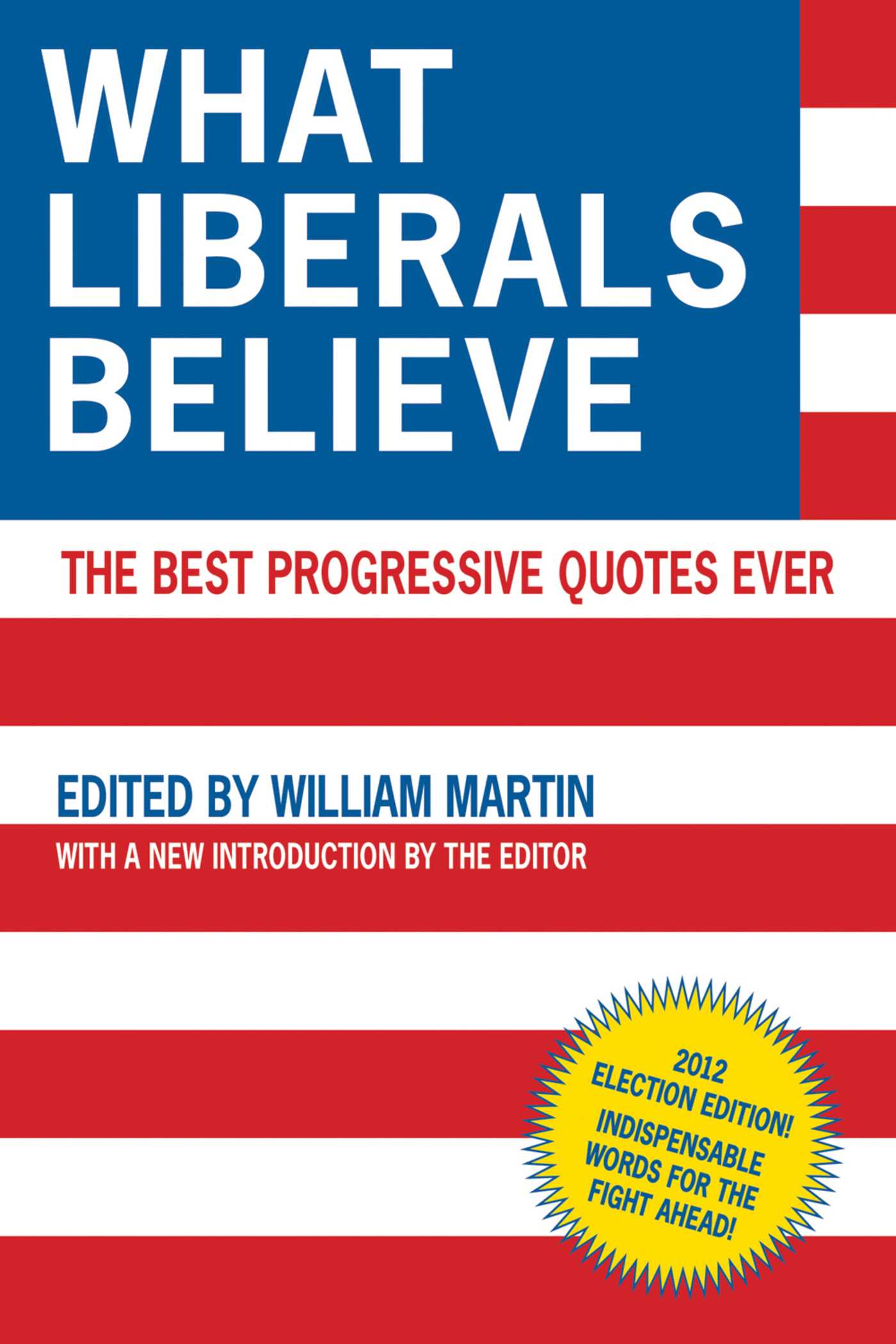
What Liberals Believe In a political and media environment dominated by conservative interests, liberals need every opportunity to be heard, without distortion and in their own words. What Liberals Believe fulfills this need by bringing together the largest collection of progressive quotations ever published. Compiled by William Martin from speeches, publications, books, blogs, and other sources, it offers wisdom and humor from the keenest progressive minds, both past and present, including Anna Quindlen, Frank Rich, Michael Moore, Oscar Wilde, Bill Clinton, Howard Dean, Rosa Parks, Barbara Ehrenreich, and John F. Kennedy. This one-of-a-kind book includes timely, insightful quotations covering hundreds of critical issues and even presents a chapter entitled "Callous and Clueless Quotes from the Right" to remind readers just how nasty and thuggish right-wing discourse has become. A perfect resource for writers, bloggers, researchers, activists, speechwriters, teachers, and students, What Liberals Believe will appeal to anyone who has grown weary of the extremism of the shameless right. With a new, updated section reflecting the 2012 presidential season, this book contains everything you need to contextualize incumbent Barack Obama with what other liberals, past and present, believe. What Liberals Believe is an excellent resource to have on hand during the upcoming election. POLITICAL SCIENCE,Commentary & Opinion

GOP GPS Editors’ Pick for the Conservative Book Club A roadmap to the future for Republicans With each passing election cycle, Republicans face stiffer and stiffer odds for winning elections at all levels. They have long relied on a combination of Baby Boomers and rural voters to propel them to victory in races for office. However, both of these populations will decline in the future. At the same time, the ranks of millennials and urban voters have exploded. Millennials (now the largest generation in the United States) and urban residents (the growing majority of the population) are the two groups that are the key to the futureboth for the United States and for any major political party. Unfortunately, the Republican Party has largely put off bringing these vital groups into the fold. In fact, it faces a real identity crisis with them. Mention the words GOP†or Republican†and they immediately react negatively. They see the party and its members as being out of touch and focused on the past. What possible reason should they have to vote for them, or even listen to their ideas? GOP GPS offers a roadmap for Republicans to win over these key groups, showing how to do so using conservative values and principles. It addresses a wide array of issues, including social justice, education, marriage equality, debt, and the family. It will challenge all and show that the Republican Party is not the caricature the Left or the media make it out to be. POLITICAL SCIENCE,Commentary & Opinion

Bernie Sanders Here is a collection of the most salient hard-hitting, no-nonsense quotes that have made Bernie Sanders the beloved leader of our revolution. The longest-serving independent in US congressional history, Sanders currently serves as US senator from Vermont and is in the race for the Democratic Party’s nomination for president. Hundreds of thousands of people across the country are flocking to Sanders’s events to hear his wisdom on political corruption, distribution of wealth, international relations, immigration, health-care reform, climate change, education, and equality. Now fans and critics alike can hear what Bernie has to say just by picking up this book. Known for his firm opinions on the economy, health care, and the environment, Bernie Sanders is a self-declared democratic socialist. He has called for free state college and university tuition, spoken out against Wall Street practices, insisted on increasing the minimum wage, and demanded tax reform. He has proposed significant health-care reforms, championed causes for veterans and senior citizens, and urged the government to address climate change in a proactive manner. A political revolution,†his campaign slogan, befits his assertion that the country is in need of an overhauleconomically, socially, and politically. As his grassroots campaign continues to explode, his social media presence flourishes and his events are attended in record-breaking numbers. Feel the Bern! POLITICAL SCIENCE,Commentary & Opinion

Unspeakable Chris Hedges on the most taboo topics in America, with David Talbot. The War on Terror is a profitable crusade against convenient enemies. Muslim rage†is an understandable response to US state terror. Rising oligarchy in America has made democracy a sham and turned the electoral process into an increasingly absurd circus. Police violence against minorities is part of a systematic effort to crush social discontent. Proliferating violence against women’s health clinics is part of the war on women’s bodies. Freedom of speech is an illusion, with government agencies and corporate media dictating acceptable boundaries of public discourse. America’s only hope is a revolution to create genuine structures of popular power. This kind of insight into America’s deeply troubled current state cannot be found on television, in the pages of leading newspapers, or on Google News. Many of our most important thinkers are relegated to the shadows because their ideas are deemed too radicalor truefor public consumption. Among these intellectual bomb throwers is Chris Hedges, who, after decades on the front lines, continues to confront power in America in the most incisive, challenging ways. Hedges’s unfettered conversation with Hot Books editorial director David Talbot founder of Salon and author of New York Times bestseller, The Devil’s Chessboard: Allen Dulles, the CIA and the Rise of America’s Secret Governmentwill be the first in a series for Hot Books called Unspeakable,†featuring some of the most important and censored voices in the world today. POLITICAL SCIENCE,Commentary & Opinion

The Future of British Politics From post-colonial arrogance to climate disaster, Frankie Boyle takes a characteristically unsparing look at the key issues on our political horizon, in this instalment of the FUTURES series POLITICAL SCIENCE,Commentary & Opinion
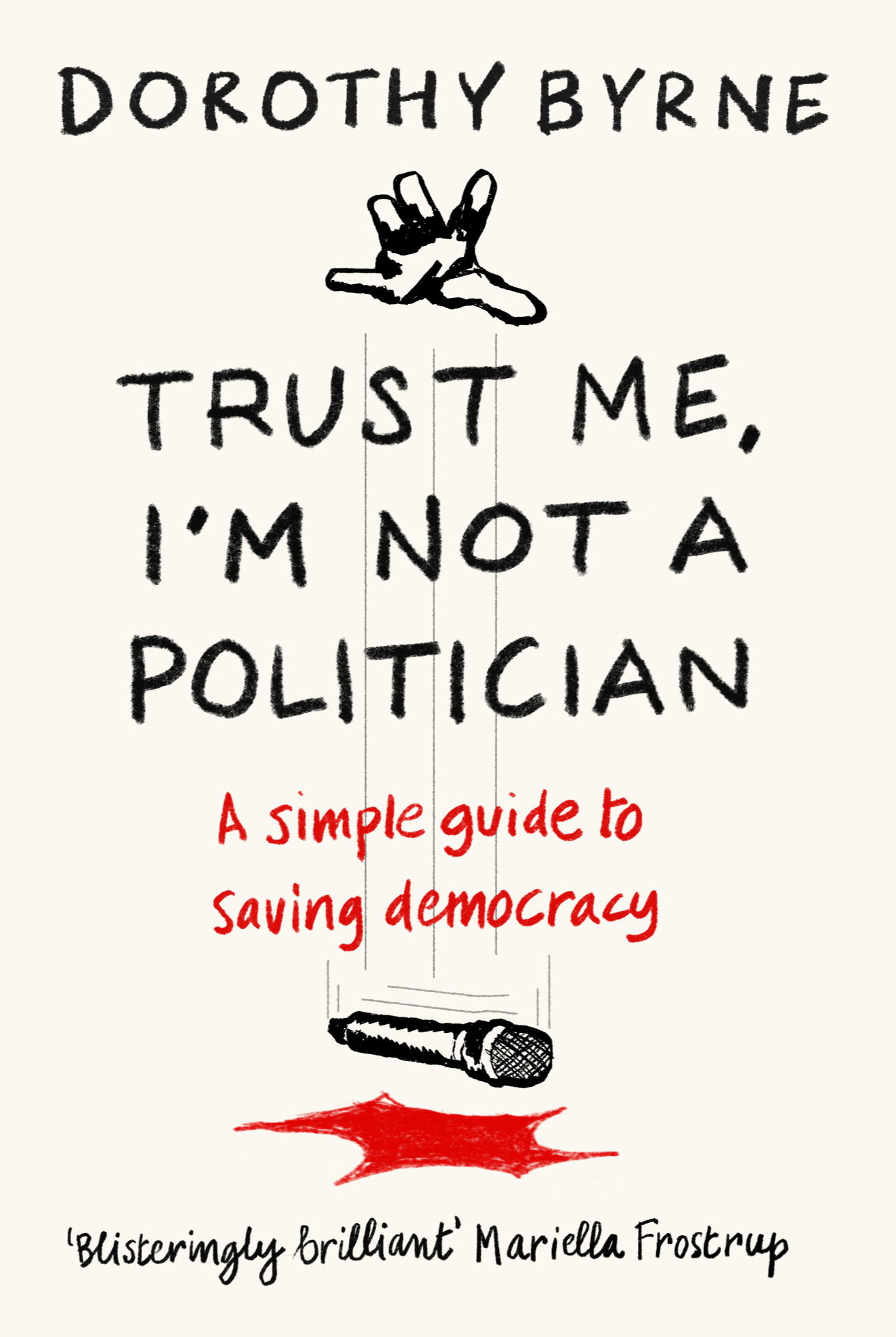
Trust Me, I'm Not A Politician In an age where more British people believe in aliens than trust our politicians, Dorothy Byrne asks the question: what went wrong and how can our trust in democracy and public life be regained? In this scintillating essay, nothing and no one escapes Byrne's razor-sharp wit as she takes on the politicians avoiding rigorous journalistic scrutiny, explores the pitfalls of impartiality, imagines what Plato might say to Trump ? and calls out plenty of sexist bastards along the way. This is a ferocious, frank, and often wildly funny attempt to separate the truth from the lies at a time of national crisis. POLITICAL SCIENCE,Commentary & Opinion
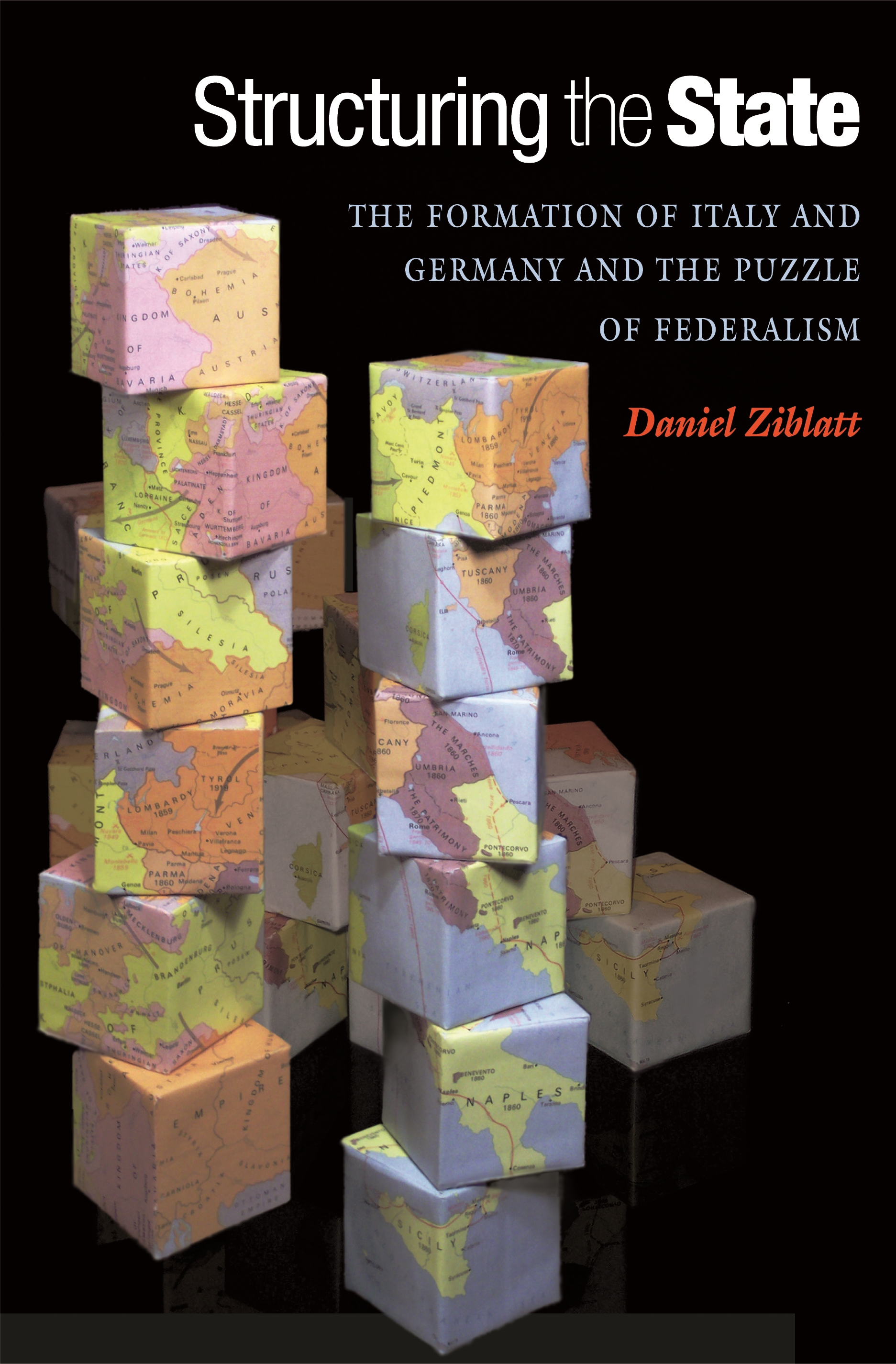
Structuring the State Germany's and Italy's belated national unifications continue to loom large in contemporary debates. Often regarded as Europe's paradigmatic instances of failed modernization, the two countries form the basis of many of our most prized theories of social science. Structuring the State undertakes one of the first systematic comparisons of the two cases, putting the origins of these nation-states and the nature of European political development in new light. Daniel Ziblatt begins his analysis with a striking puzzle: Upon national unification, why was Germany formed as a federal nation-state and Italy as a unitary nation-state? He traces the diplomatic maneuverings and high political drama of national unification in nineteenth-century Germany and Italy to refute the widely accepted notion that the two states' structure stemmed exclusively from Machiavellian farsightedness on the part of militarily powerful political leaders. Instead, he demonstrates that Germany's and Italy's "founding fathers" were constrained by two very different pre-unification patterns of institutional development. In Germany, a legacy of well-developed sub-national institutions provided the key building blocks of federalism. In Italy, these institutions' absence doomed federalism. This crucial difference in the organization of local power still shapes debates about federalism in Italy and Germany today. By exposing the source of this enduring contrast, Structuring the State offers a broader theory of federalism's origins that will interest scholars and students of comparative politics, state-building, international relations, and European political history. POLITICAL SCIENCE,Comparative Politics

The Black Nile A spectacular modern-day adventure along the Nile River from Lake Victoria to the Mediterranean Sea With news of tenuous peace in Sudan, foreign correspondent Dan Morrison bought a plank-board boat, summoned a childhood friend who'd never been off American soil and set out from Uganda, paddling the White Nile on a quest to reach Cairo-a trip that tyranny and war had made impossible for decades. Morrison's chronicle is a mashup of travel narrative and reportage, packed with flights into the frightful and the absurd. Through river mud that engulfs him and burning marshlands that darken the sky, he tracks the snarl of commonalities and conflicts that bleed across the Nile valley, bringing to life the waters that connect the hardscrabble fishing villages of Lake Victoria to the floating Cairo nightclubs where headscarved mothers are entertained by gyrating male dancers. In between are places and lives invisible to cable news and opinion blogs: a hidden oil war that has erased entire towns, secret dams that will flood still more and contested borderlands where acts of compassion and ingenuity defy appalling hardship and waste of life. As Morrison dodges every imaginable hazard, from militia gunfire to squalls of sand, his mishaps unfold in strange harmony with the breathtaking range of individuals he meets along the way. Relaying the voices of Sudanese freedom fighters and escaped Ugandan sex slaves, desert tribesmen and Egyptian tomb raiders, The Black Nile culminates in a visceral understanding of one of the world's most elusive hotspots, where millions strive to claw their way from war and poverty to something better-if only they could agree what that something is, whom to share it with, and how to get there. With the propulsive force of a thriller, The Black Nile is rife with humor, humanity and fervid insight-an unparalleled portrait of a complex territory in profound transition. POLITICAL SCIENCE,Comparative Politics
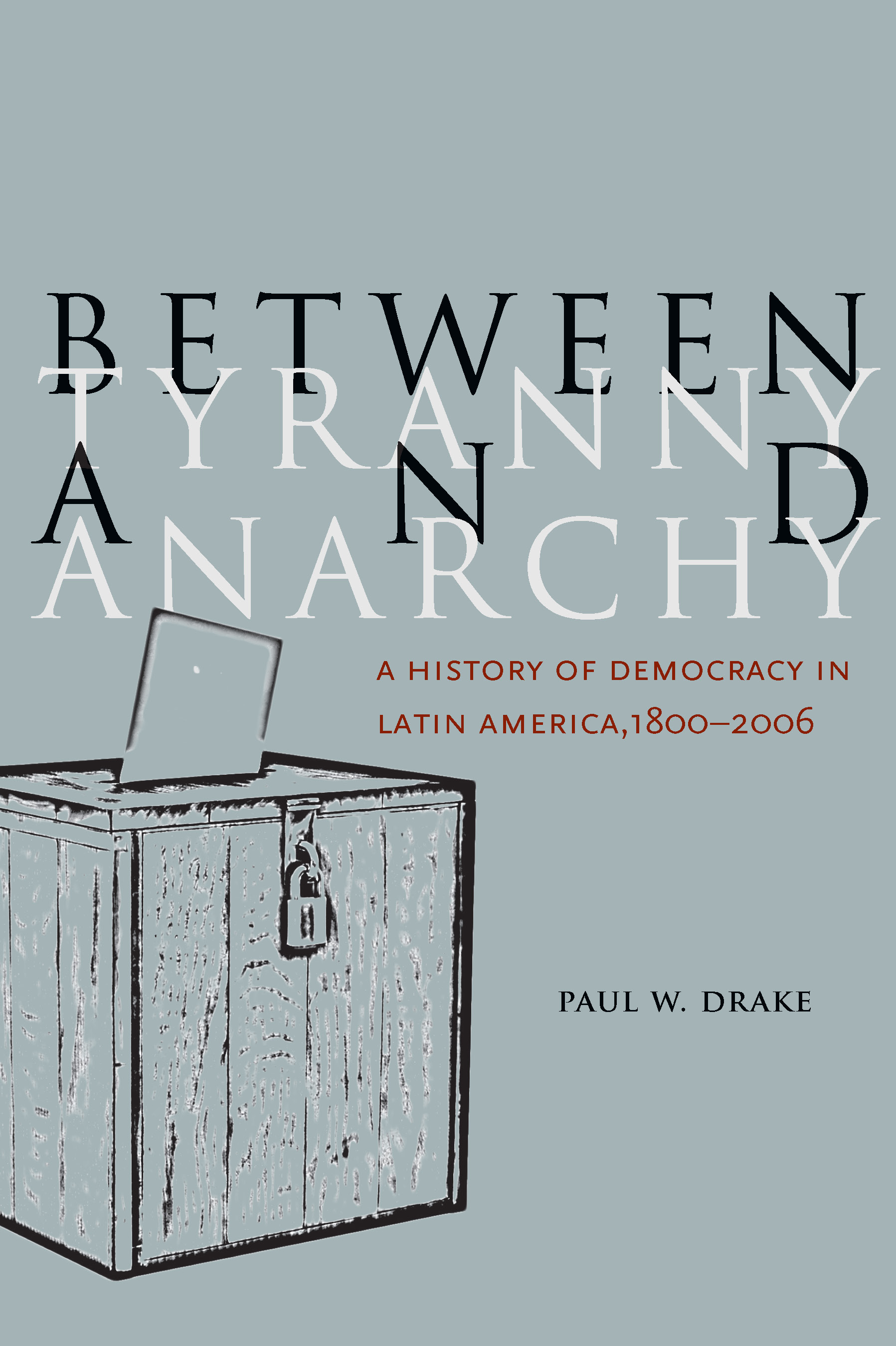
Between Tyranny and Anarchy Between Tyranny and Anarchy provides a unique comprehensive history and interpretation of efforts to establish democracies over two centuries in the major Latin American countries. POLITICAL SCIENCE,Comparative Politics
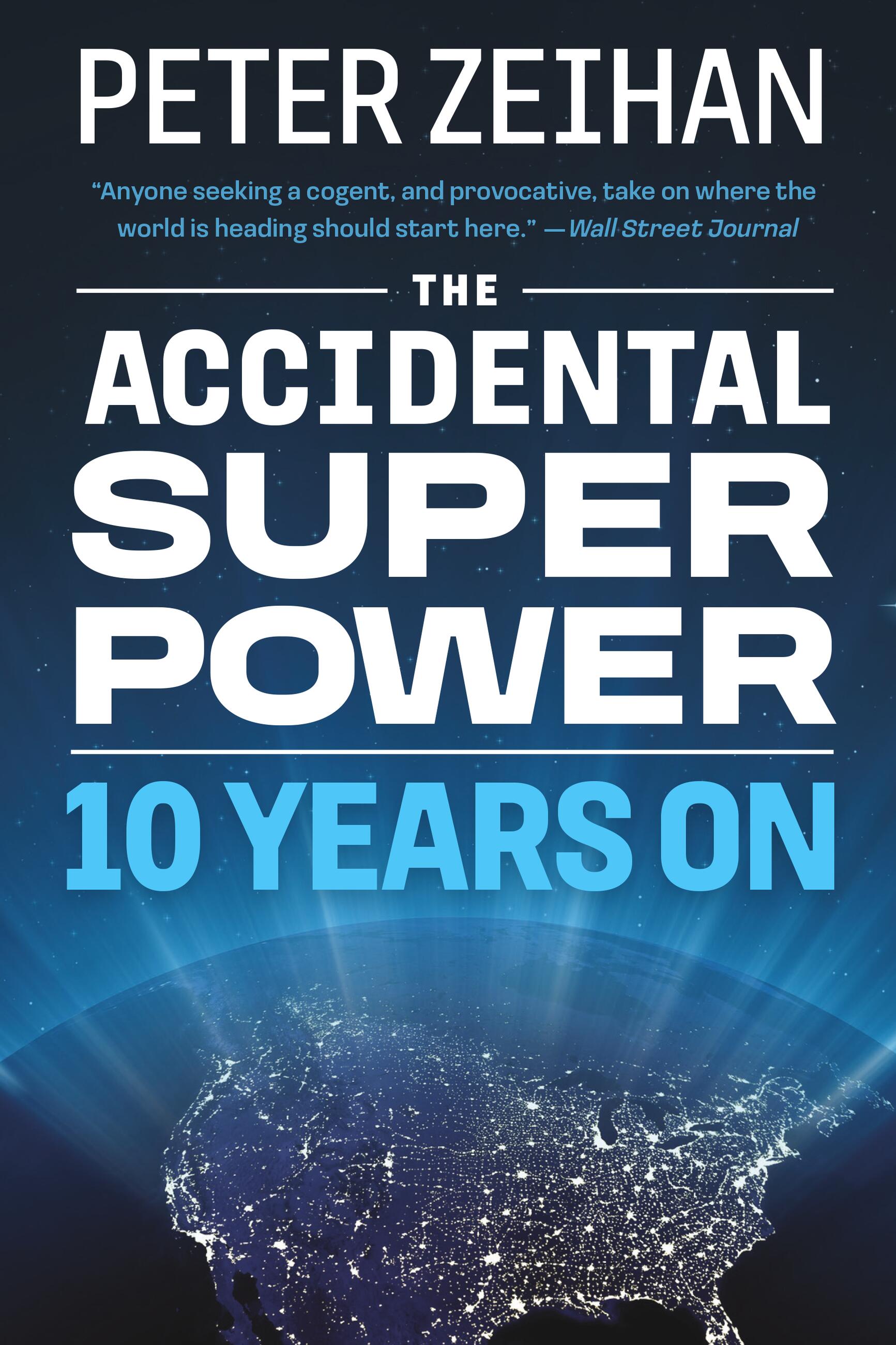
The Accidental Superpower An eye-opening assement of American power and deglobalization in the bestselling tradition of The World is Flat and The Next 100 Years. Near the end of the Second World War, the United States made a bold strategic gambit that rewired the international system. Empires were abolished and replaced by a global arrangement enforced by the U.S. Navy. With all the world's oceans safe for the first time in history, markets and resources were made available for everyone. Enemies became partners. We think of this system as normal - it is not. We live in an artificial world on borrowed time. In The Accidental Superpower, international strategist Peter Zeihan examines how the hard rules of geography are eroding the American commitment to free trade; how much of the planet is aging into a mass retirement that will enervate markets and capital supplies; and how, against all odds, it is the ever-ravenous American economy that - alone among the developed nations - is rapidly approaching energy independence. Combined, these factors are doing nothing less than overturning the global system and ushering in a new (dis)order. For most, that is a disaster-in-waiting, but not for the Americans. The shale revolution allows Americans to sidestep an increasingly dangerous energy market. Only the United States boasts a youth population large enough to escape the sucking maw of global aging. Most important, geography will matter more than ever in a de-globalizing world, and America's geography is simply sublime. POLITICAL SCIENCE,Comparative Politics
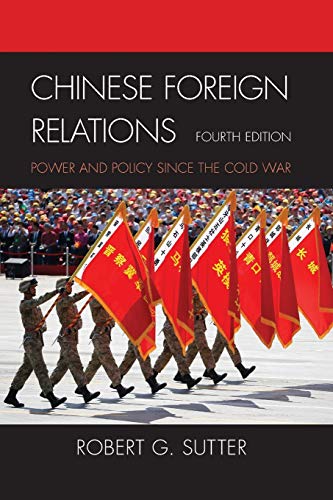
Chinese Foreign Relations This comprehensive introduction to Chinese foreign relations assesses the accomplishments and limits China faces as it exerts increasing international influence. Sutter's balanced and thorough assessment shows China's leaders exerting more influence in world affairs but remaining far from dominant, even in key areas along China’s border. POLITICAL SCIENCE,Comparative Politics

After Victory The end of the Cold War was a "big bang" reminiscent of earlier moments after major wars, such as the end of the Napoleonic Wars in 1815 and the end of the world wars in 1919 and 1945. But what do states that win wars do with their newfound power, and how do they use it to build order? In After Victory, John Ikenberry examines postwar settlements in modern history, arguing that powerful countries do seek to build stable and cooperative relations, but the type of order that emerges hinges on their ability to make commitments and restrain power. He explains that only with the spread of democracy in the twentieth century and the innovative use of international institutions—both linked to the emergence of the United States as a world power—has order been created that goes beyond balance of power politics to exhibit "constitutional" characteristics. Blending comparative politics with international relations, and history with theory, After Victory will be of interest to anyone concerned with the organization of world order, the role of institutions in world politics, and the lessons of past postwar settlements for today. POLITICAL SCIENCE,Comparative Politics
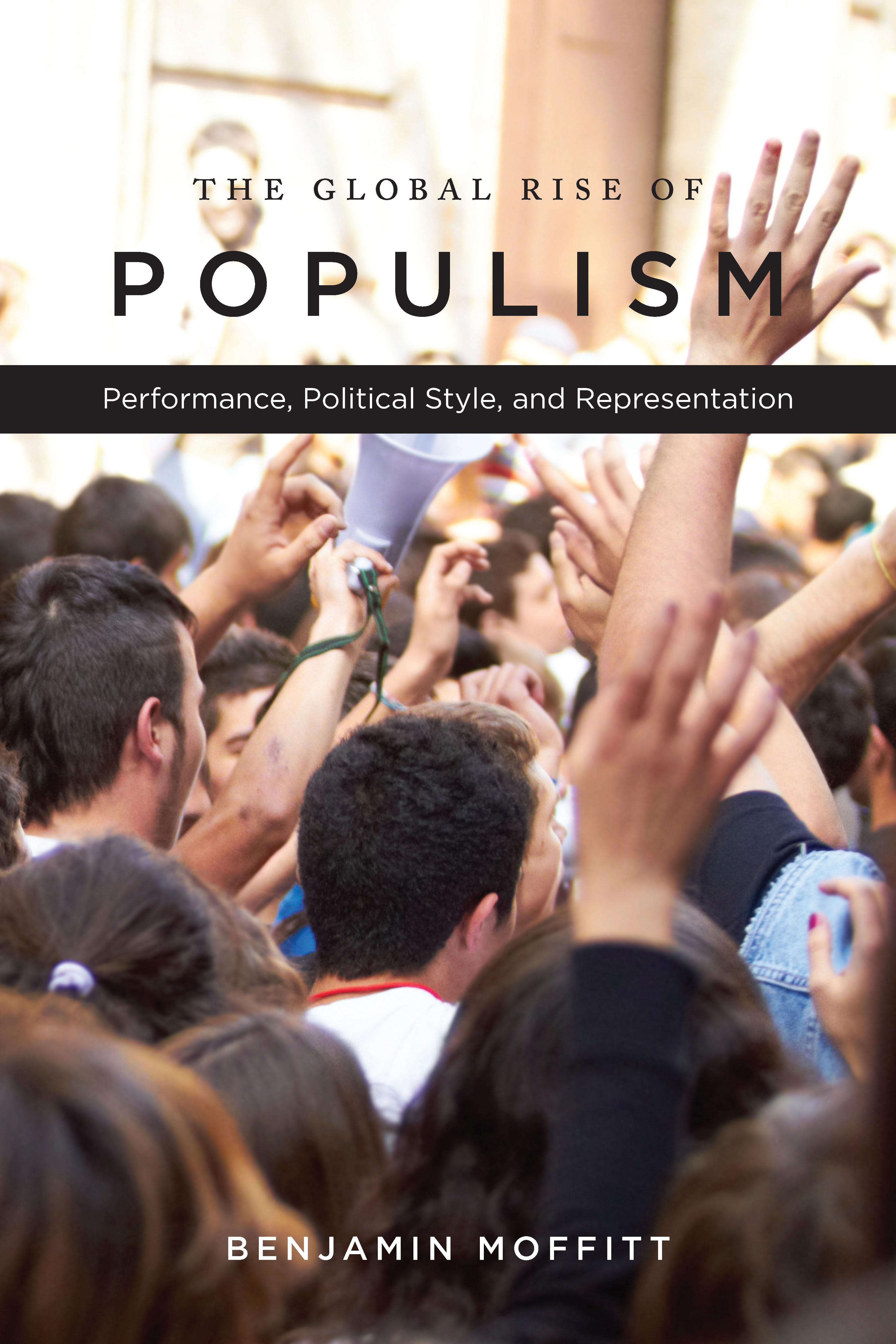
The Global Rise of Populism Once seen as a fringe phenomenon, populism is back. While some politicians and media outlets present it as dangerous to the U.S., Europe, and Latin America, others hail it as the fix for broken democracies. Not surprisingly, questions about populism abound. Does it really threaten democracy? Why the sudden rise in populism? And what are we talking about when we talk about "populism"? The Global Rise of Populism argues for the need to rethink this concept. While still based on the classic divide between "the people" and "the elite," populism's reliance on new media technologies, its shifting relationship to political representation, and its increasing ubiquity have seen it transform in nuanced ways that demand explaining. Benjamin Moffitt contends that populism is not one entity, but a political style that is performed, embodied, and enacted across different political and cultural contexts. This new understanding makes sense of populism in a time when media pervades political life, a sense of crisis prevails, and populism has gone truly global. POLITICAL SCIENCE,Comparative Politics
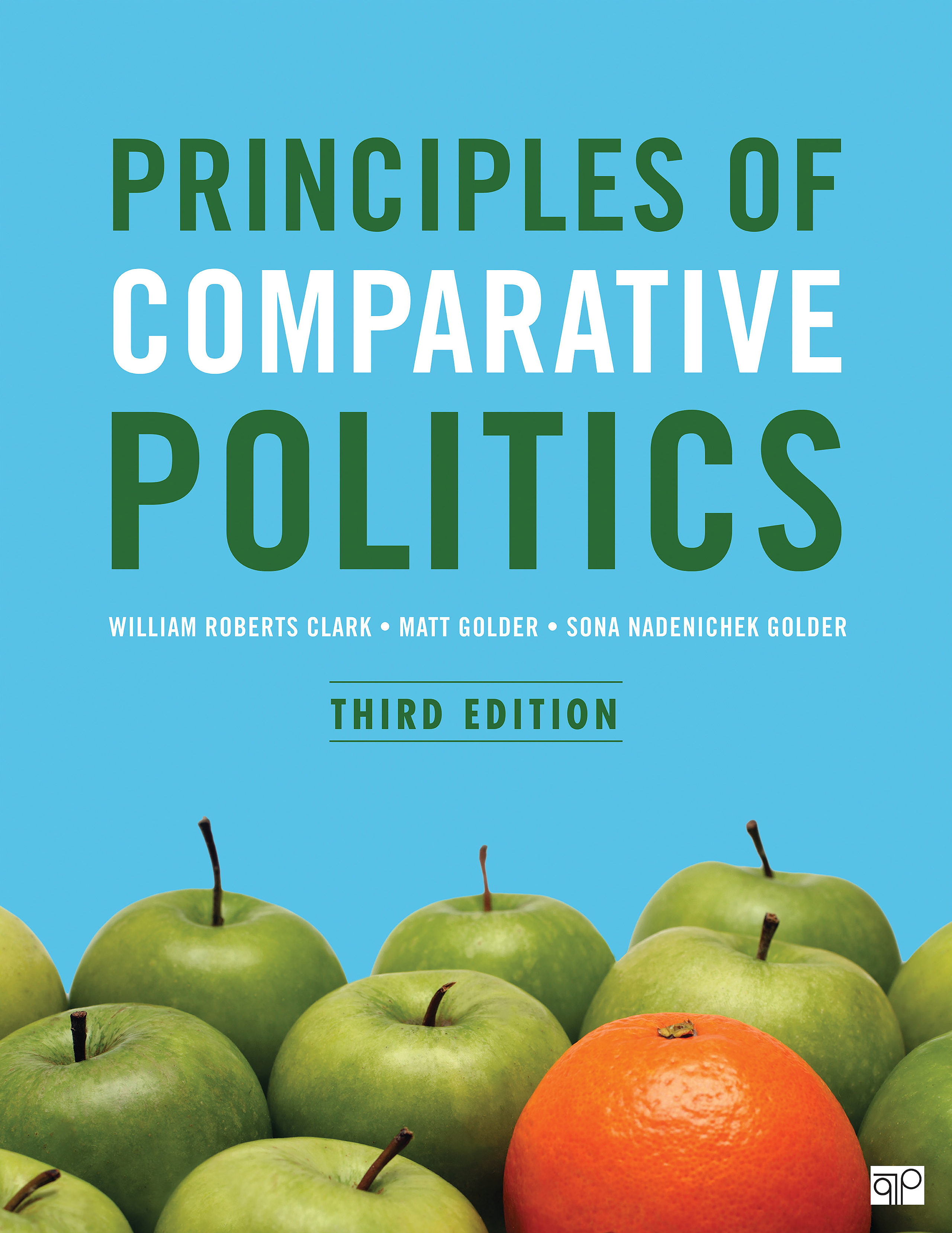
Principles of Comparative Politics William Roberts Clark, Matt Golder, and Sona Nadenichek Golder’s groundbreaking Principles of Comparative Politics offers the most comprehensive and up-to-date introduction to comparative inquiry, research, and scholarship. In this thoroughly revised Third Edition, readers have an even better guide to cross-national comparison and why it matters. Readers are offered a new intuitive take on statistical analyses and a clearer explanation of how to interpret regression results; a thoroughly-revised chapter on culture and democracy that now includes a more extensive discussion of cultural modernization theory and a new overview of survey methods for addressing sensitive topics; and a revised chapter on dictatorships that incorporates a principal-agent framework for understanding authoritarian institutions. Examples from the gender and politics literature have been incorporated into various chapters and empirical examples and data on various types of institutions have been updated. The book's outstanding pedagogy includes more than 250 tables and figures, numerous photos and maps, end of chapter exercises and problem sets, and a broader set of works cited. New to this Edition A new intuitive take on statistical analyses and a clearer explanation of how to interpret regression results are included. A thoroughly-revised chapter on culture and democracy includes a more extensive discussion of cultural modernization theory and a new overview of survey methods for addressing sensitive topics. A revised chapter on dictatorships incorporates a principal-agent framework for understanding authoritarian institutions. Examples from the gender and politics literature have been incorporated into various chapters. Empirical examples and data on various types of institutions have been updated. Online videos and tutorials guide students through some of the methodological components addressed in the book. POLITICAL SCIENCE,Comparative Politics
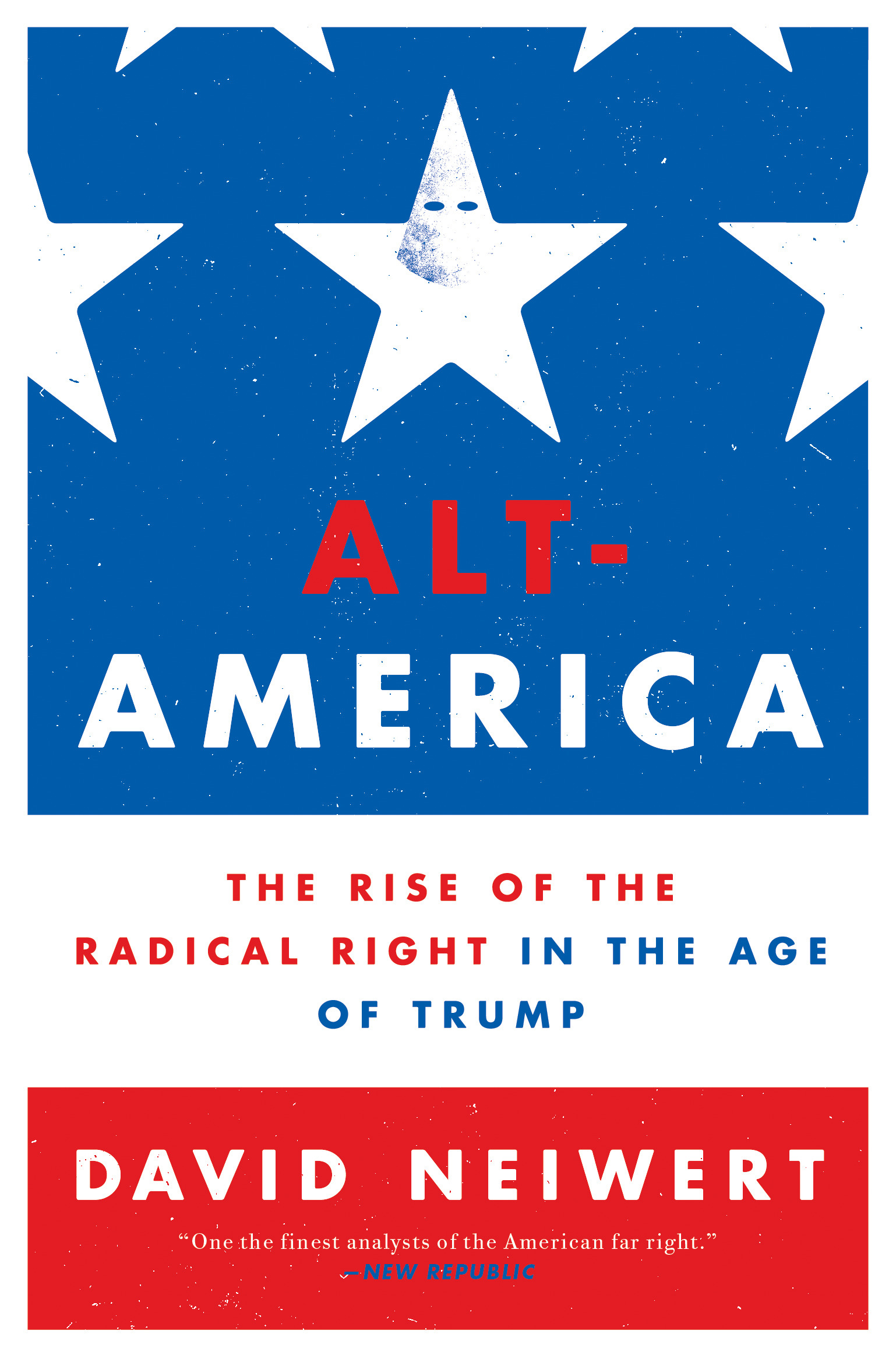
Alt-America The story of the remarkable resurgence of right-wing extremists in the United States Just as Donald Trump’s victorious campaign for the US presidency shocked the world, the seemingly sudden national prominence of white supremacists, xenophobes, militia leaders, and mysterious “alt-right” figures mystifies many. But the American extreme right has been growing steadily in number and influence since the 1990s with the rise of patriot militias. Following 9/11, conspiracy theorists found fresh life; and in virulent reaction to the first black US president, militant racists have come out of the woodwork. Nurtured by a powerful right-wing media sector in radio, TV, and online, the far right, Tea Party movement conservatives, and Republican activists found common ground. Figures such as Stephen Bannon, Milo Yiannopoulos, and Alex Jones, once rightly dismissed as cranks, now haunt the reports of mainstream journalism. Investigative reporter David Neiwert has been tracking extremists for more than two decades. In Alt-America, he provides a deeply researched and authoritative report on the growth of fascism and far-right terrorism, the violence of which in the last decade has surpassed anything inspired by Islamist or other ideologies in the United States. The product of years of reportage, and including the most in-depth investigation of Trump’s ties to the far right, this is a crucial book about one of the most disturbing aspects of American society. POLITICAL SCIENCE,Comparative Politics

How To Stop Brexit (And Make Britain Great Again) *THE SUNDAY TIMES BESTSELLER* Keep calm – but do not carry on. There is nothing remotely inevitable about Brexit – except that it will be deeply damaging if it happens. Extricating Britain from Europe will be the greatest challenge this country has faced since the Second World War. And as negotiations with the EU expose the promises of the Brexit campaign to have been hollow, even some Brexit-voters now wish to exercise their democratic right to change their mind, seeing that the most pragmatic option is to … stop. It would certainly be the best thing for Britain. But how can it be done? Haven’t the people spoken? No. In this indispensable handbook, Nick Clegg categorically debunks the various myths that have been used to force Brexit on Britain, not by ‘the people’ but by a small, extremely rich, self-serving elite, and explains precisely how this historic mistake can be reversed – and what you can do to make sure that it is. POLITICAL SCIENCE,Comparative Politics
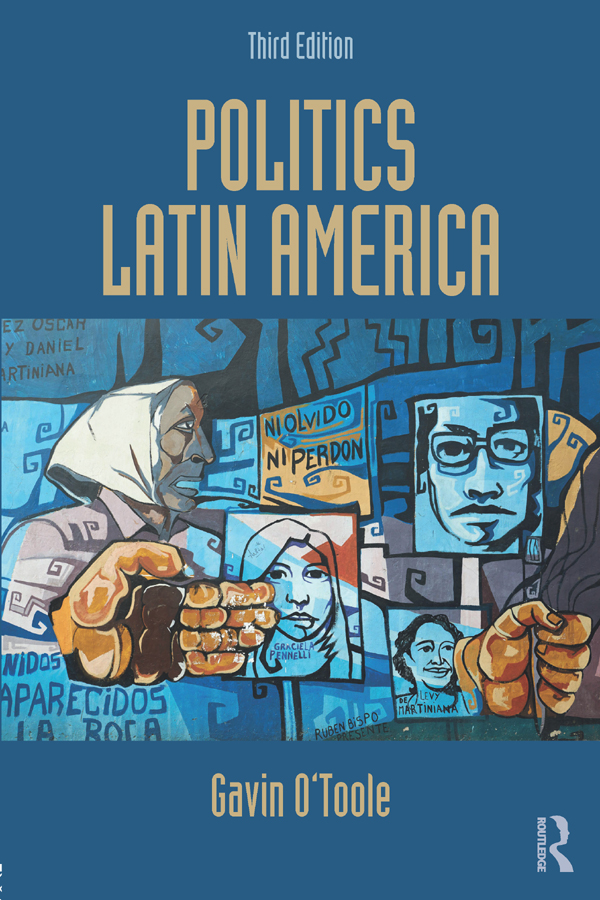
Politics Latin America Politics Latin America examines the role of Latin America in the world and its importance to the study of politics with particular emphasis on the institutions and processes that exist to guarantee democracy and the forces that threaten to compromise it. Now in its third edition and fully revised to reflect recent developments in the region, Politics Latin America provides students and teachers with an accessible overview of the region’s unique political and economic landscape, covering every aspect of governance in its 21 countries. The book examines the international relations of Latin American states as they seek to carve out a role in an increasingly globalised world and will be an ideal introduction for undergraduate courses in Latin American politics, comparative politics, and other disciplines. This new edition will include: updated references to scholarship and debates; new themes such as environmental rights, women presidents, the Latin American Pope, Afro-Latinos, and the politics of sexual diversity; examination of demographic change and social movements; a new chapter on environmental economics and sustainable development. This book is essential reading for undergraduates taking courses in Latin American Politics. POLITICAL SCIENCE,Comparative Politics

Prison Bureaucracies in the United States, Mexico, India, and Honduras This book examines how the form and function of prisons in the United States, Mexico, India, and Honduras differ, as evidenced by data gathered from interviews with 150 prison administrators in ten international trips. Despite many variations between the fifteen prisons and four systems in this study, they had strikingly similar long-term paths. POLITICAL SCIENCE,Comparative Politics

Why America Must Not Follow Europe Daniel Hannan, a British Conservative Member of the European Parliament, calls on Americans to avoid Europe's future. He traces the common roots of British and American liberty, and describes how both countries are losing their inheritance as government crowds out the private sphere. He calls for a renewed commitment to the Anglosphere: the alliance of free, English-speaking nations which has preserved freedom in our time. POLITICAL SCIENCE,Comparative Politics
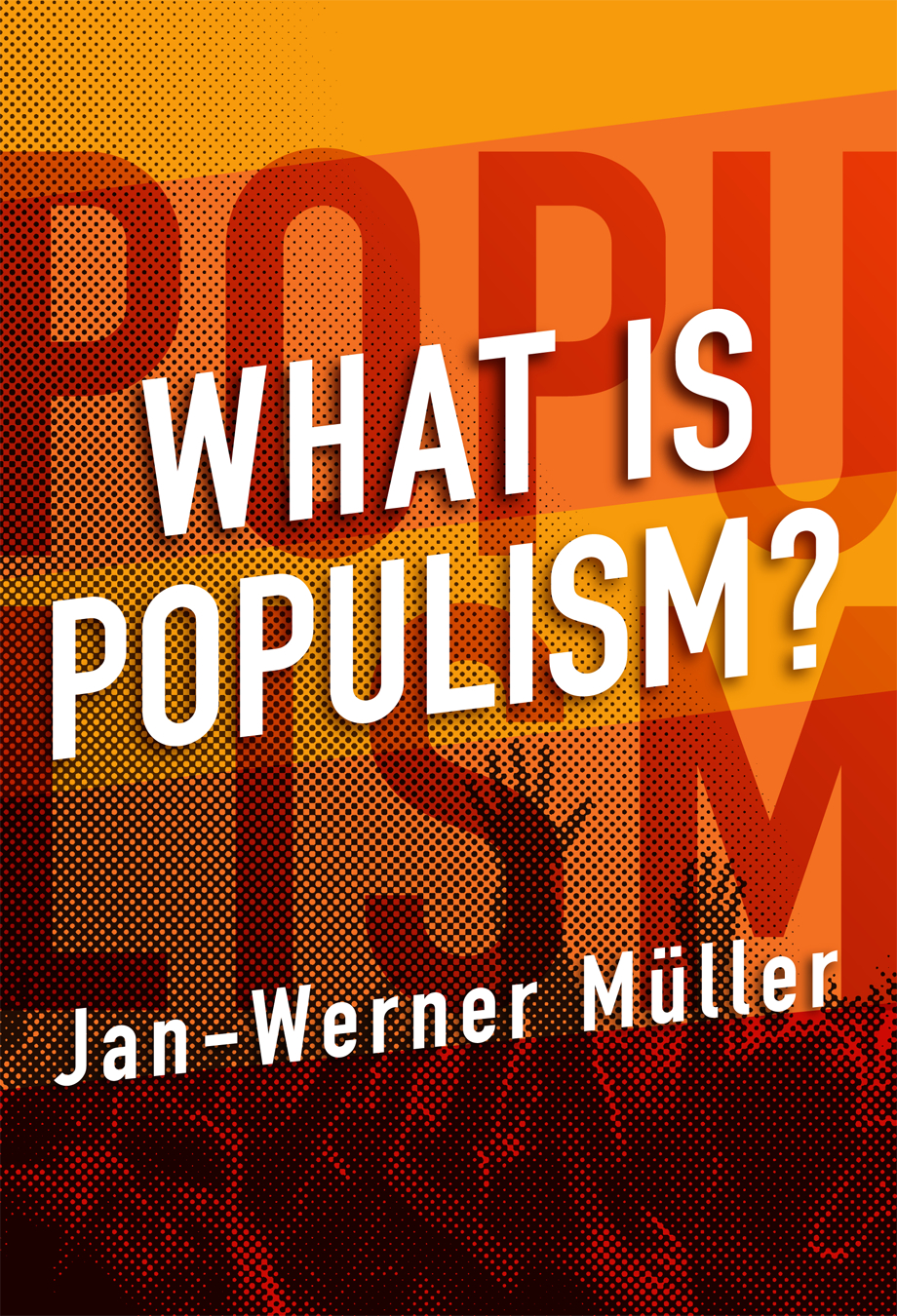
What Is Populism? Donald Trump, Silvio Berlusconi, Marine Le Pen, Hugo Chávez—populists are on the rise across the globe. But what exactly is populism? Should everyone who criticizes Wall Street or Washington be called a populist? What precisely is the difference between right-wing and left-wing populism? Does populism bring government closer to the people or is it a threat to democracy? Who are "the people" anyway and who can speak in their name? These questions have never been more pressing. In this groundbreaking volume, Jan-Werner Müller argues that at populism's core is a rejection of pluralism. Populists will always claim that they and they alone represent the people and their true interests. Müller also shows that, contrary to conventional wisdom, populists can govern on the basis of their claim to exclusive moral representation of the people: if populists have enough power, they will end up creating an authoritarian state that excludes all those not considered part of the proper "people." The book proposes a number of concrete strategies for how liberal democrats should best deal with populists and, in particular, how to counter their claims to speak exclusively for "the silent majority" or "the real people." Analytical, accessible, and provocative, What Is Populism? is grounded in history and draws on examples from Latin America, Europe, and the United States to define the characteristics of populism and the deeper causes of its electoral successes in our time. POLITICAL SCIENCE,Comparative Politics
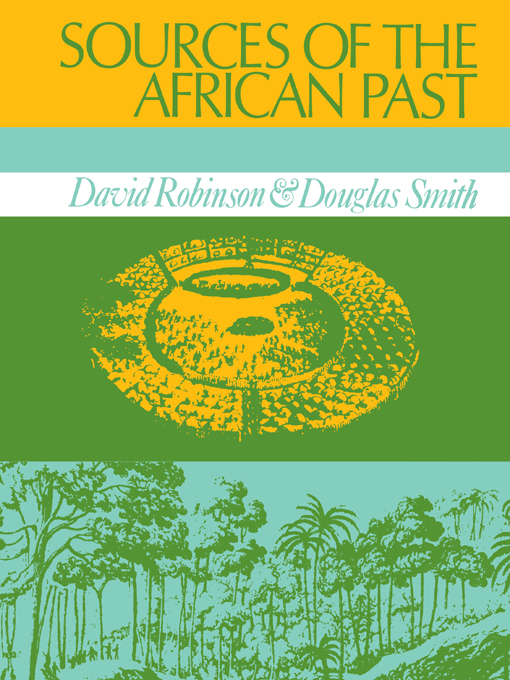
Sources of the African Past Sources of the African Past combines a case-study approach with an emphasis on primary and orally transmitted sources to accomplish three objectives; to tell a story in some depth, to portray major themes and to raise basic questions of analysis and interpretation. The case studies are set in the nineteenth century and deal with critical periods in the fortunes of five societies in different parts of the continent (South, East, and West Africa). The authors wish students to work with the "raw" materials of history and to that end have provided a workbook for a "laboratory" experience. Sources of the African Past is designed for use in a wide variety of courses and in conjuction with other texts. The authors have kept their own interpretations to a minimum and invited scrutiny of their decision of selection and arrangement. They chose the cases on the basis of several criteria: geographical coverage, abundance and diversity of primary sources, importance in the secondary literature, and relevance to important historical problems. All the studies emphasize political change. All witness some growth in European intervention. In selecting the documents, the authors sought a balance of perspective without sacrificing accuracy and relevance. This means a conscious effort to present a variety of views: African and European, internal and external, partipant and observer, those of the victims as well as those of the victors, those of the "people" as well as those of the elite. Within the limitations of space, they have made the excerpts sufficiently long to allow the reader to examine the author's style, purpose and other characteristics. Keeping in mind the limitations of libraries, they have attemted to make each chapter self-contained. POLITICAL SCIENCE,Comparative Politics
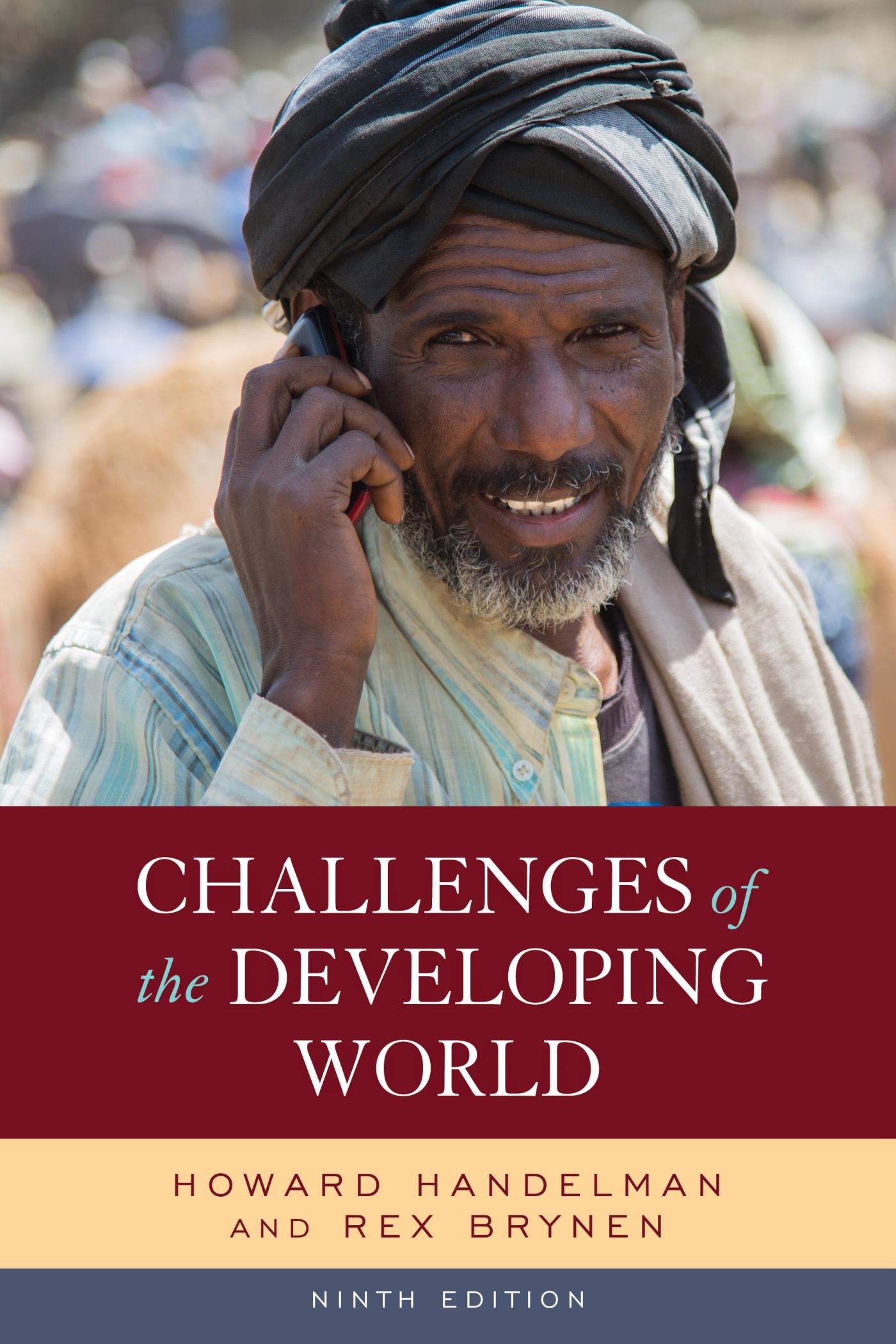
Challenges of the Developing World Challenges of the Developing World is a lively, up-to-date, and highly readable introduction to the key dynamics and issues of political, economic and social development in the “developing countries†of Africa, Asia, the Middle East, and Latin America. POLITICAL SCIENCE,Comparative Politics
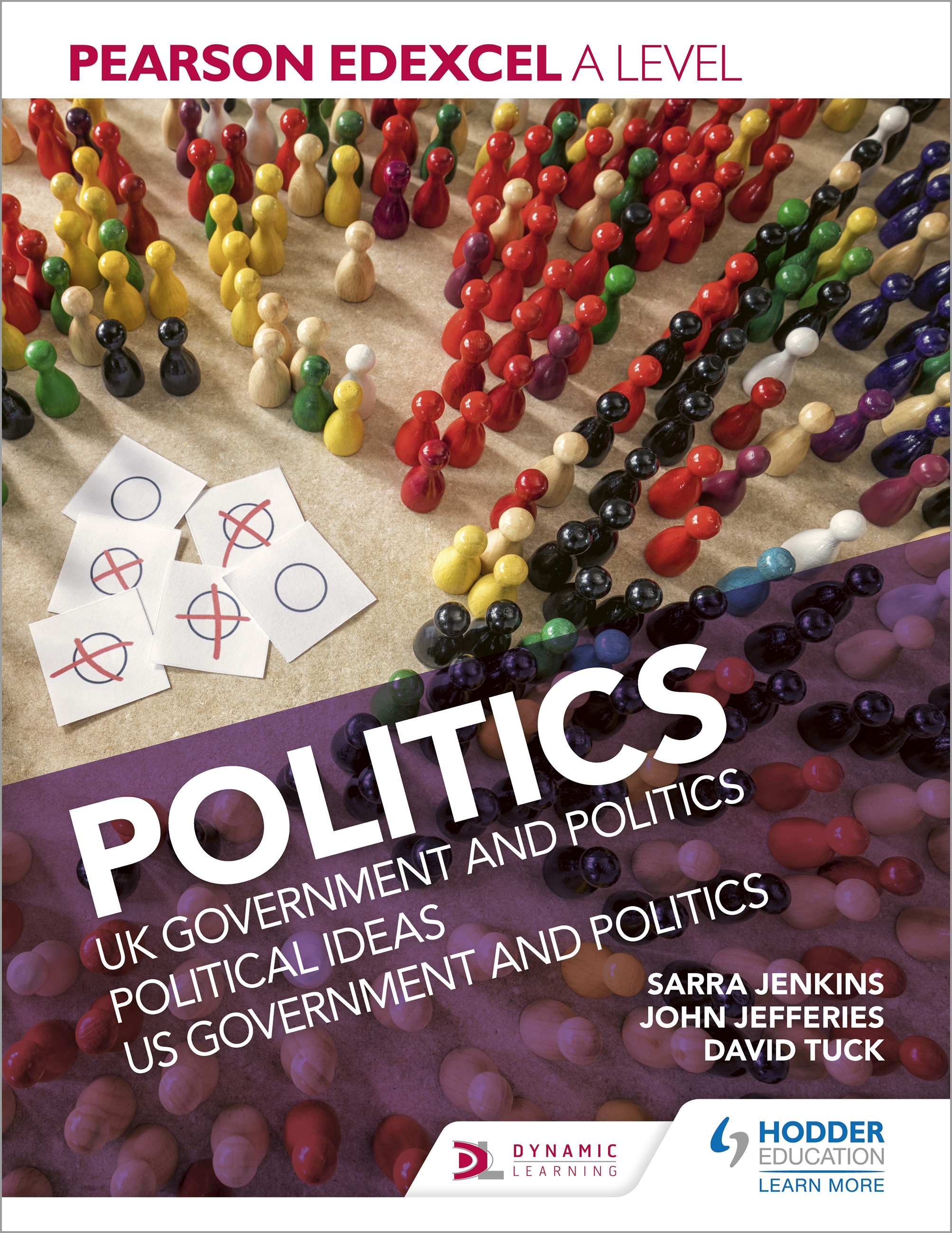
Pearson Edexcel A level Politics This all-in-one textbook provides in-depth coverage of specification content and recent political developments and helps students to apply their knowledge through case studies, debates on key issues and practice questions. - Includes all core and non-core political ideas, with key thinkers thoroughly integrated into the theory- Provides complete guidance to the USA route of the specification- Strengthens understanding by interweaving both historical context and contemporary examples, such as Brexit, into the text- Builds confidence by highlighting key terms and explaining synoptic links between different topics in the specification- Develops analysis and evaluation skills with 'stretch and challenge' activities- Features practice questions with answer guidance online Available in print as Student Textbooks or in two digital formats: Student eTextbooks are downloadable versions of the printed textbooks purchased on a copy-by-copy basis and allocated to the students in Dynamic Learning Whiteboard eTextbooks are online, interactive versions of the textbooks for front-of-class teaching and lesson planning We are seeking endorsement from Pearson Edexcel for the Student Textbook and Student eTextbook. POLITICAL SCIENCE,Comparative Politics

The Narrow Corridor From the authors of the international bestseller Why Nations Fail, a crucial new big-picture framework that answers the question of how liberty flourishes in some states but falls to authoritarianism or anarchy in others--and explains how it can continue to thrive despite new threats. In Why Nations Fail, Daron Acemoglu and James A. Robinson argued that countries rise and fall based not on culture, geography, or chance, but on the power of their institutions. In their new book, they build a new theory about liberty and how to achieve it, drawing a wealth of evidence from both current affairs and disparate threads of world history. Liberty is hardly the "natural" order of things. In most places and at most times, the strong have dominated the weak and human freedom has been quashed by force or by customs and norms. Either states have been too weak to protect individuals from these threats, or states have been too strong for people to protect themselves from despotism. Liberty emerges only when a delicate and precarious balance is struck between state and society. There is a Western myth that political liberty is a durable construct, arrived at by a process of "enlightenment." This static view is a fantasy, the authors argue. In reality, the corridor to liberty is narrow and stays open only via a fundamental and incessant struggle between state and society: The authors look to the American Civil Rights Movement, Europe’s early and recent history, the Zapotec civilization circa 500 BCE, and Lagos’s efforts to uproot corruption and institute government accountability to illustrate what it takes to get and stay in the corridor. But they also examine Chinese imperial history, colonialism in the Pacific, India’s caste system, Saudi Arabia’s suffocating cage of norms, and the “Paper Leviathan” of many Latin American and African nations to show how countries can drift away from it, and explain the feedback loops that make liberty harder to achieve. Today we are in the midst of a time of wrenching destabilization. We need liberty more than ever, and yet the corridor to liberty is becoming narrower and more treacherous. The danger on the horizon is not "just" the loss of our political freedom, however grim that is in itself; it is also the disintegration of the prosperity and safety that critically depend on liberty. The opposite of the corridor of liberty is the road to ruin. POLITICAL SCIENCE,Comparative Politics

Reckless opportunists Aeron Davis looks at the growing crisis of leadership in Britain today. He argues that increasingly self-interested elites are not only damaging society they are destroying the basis of Establishment rule itself. The book, based on over 350 elite interviews, asks: how did we end up producing the leaders that got us here and what can we do about it? POLITICAL SCIENCE,Comparative Politics
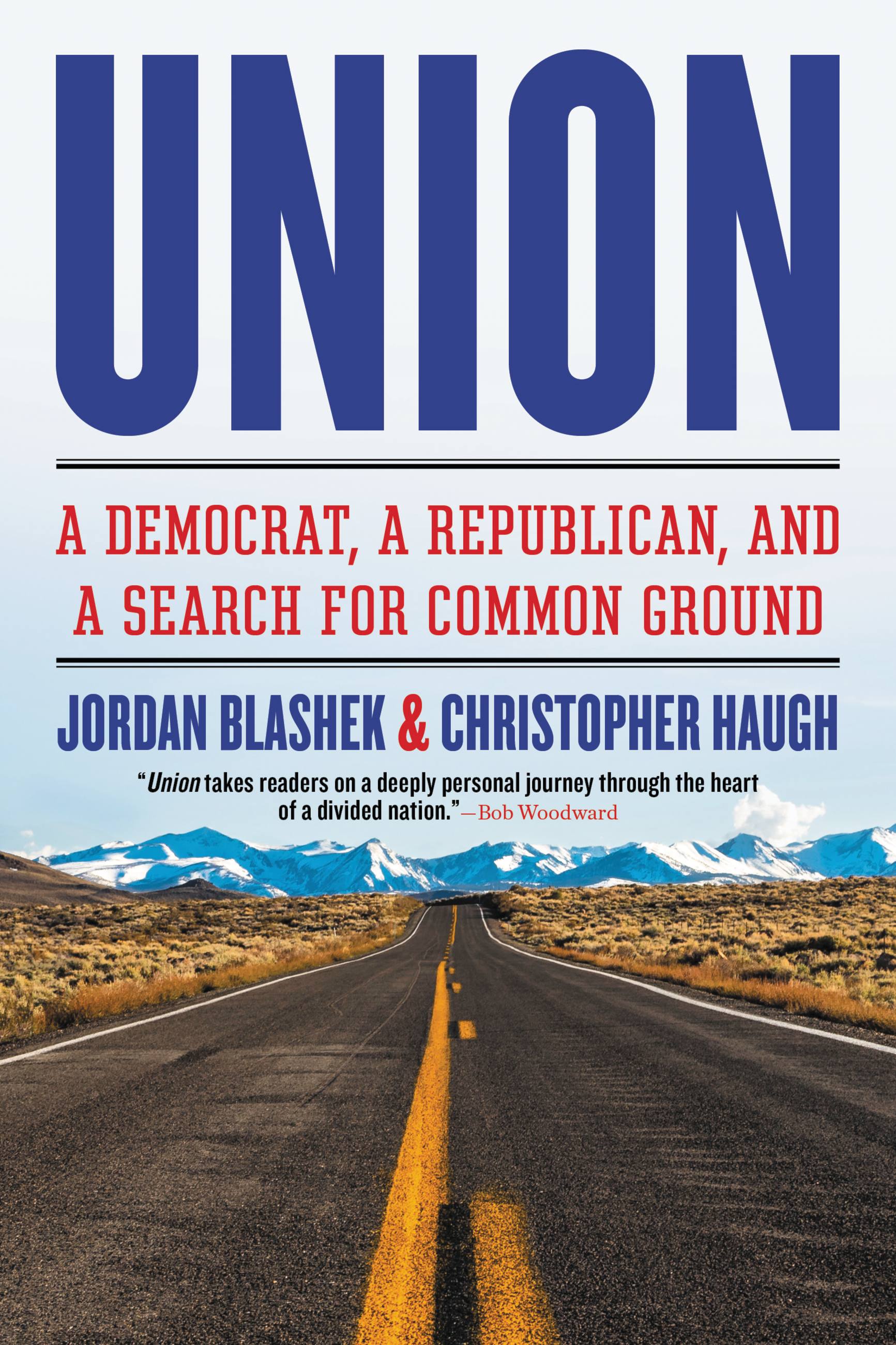
Union Two friends -- a Democrat and a Republican -- travel across America "on a deeply personal journey through the heart of a divided nation...to find growth, hope and fundamental strength in their own lives" (Bob Woodward) and the country they love, in good times and bad. In the year before Donald Trump was elected president, Jordan Blashek, a Republican Marine, and Chris Haugh, a Democrat and son of a single mother from Berkeley, CA, formed an unlikely friendship. Jordan was fresh off his service in the Marines and feeling a bit out of place at Yale Law School. Chris was yearning for a sense of mission after leaving Washington D.C. Over the months, Jordan and Chris's friendship blossomed not in spite of, but because of, their political differences. So they decided to hit the road in search of reasons to strengthen their bond in an era of strife and partisanship. What follows is a three-year adventure story, across forty-four states and along 20,000 miles of road to find out exactly where the American experiment stands at the close of the second decade of the twenty-first century. In their search, Jordan and Chris go from the tear gas-soaked streets of a Trump rally in Phoenix, Arizona to the Mexican highways running between Tijuana and Juarez. They witness the full scope of American life, from lobster trawlers and jazz clubs of Portland and New Orleans to the streets of Tulsa, Oklahoma and the prisons of Detroit, where former addicts and inmates painstakingly put their lives back together. Union is a road narrative, a civics lesson, and an unforgettable window into one epic friendship. We ride along with Jordan and Chris for the whole journey, listening in on front-seat arguments and their conversations with Americans from coast to coast. We also peer outside the car to understand America's hot-button topics, including immigration, mass incarceration, and the military-civilian divide. And by the time Jordan and Chris kill the engine for the last time, they answer one of the most pressing questions of our time: How far apart are we really? POLITICAL SCIENCE,Comparative Politics
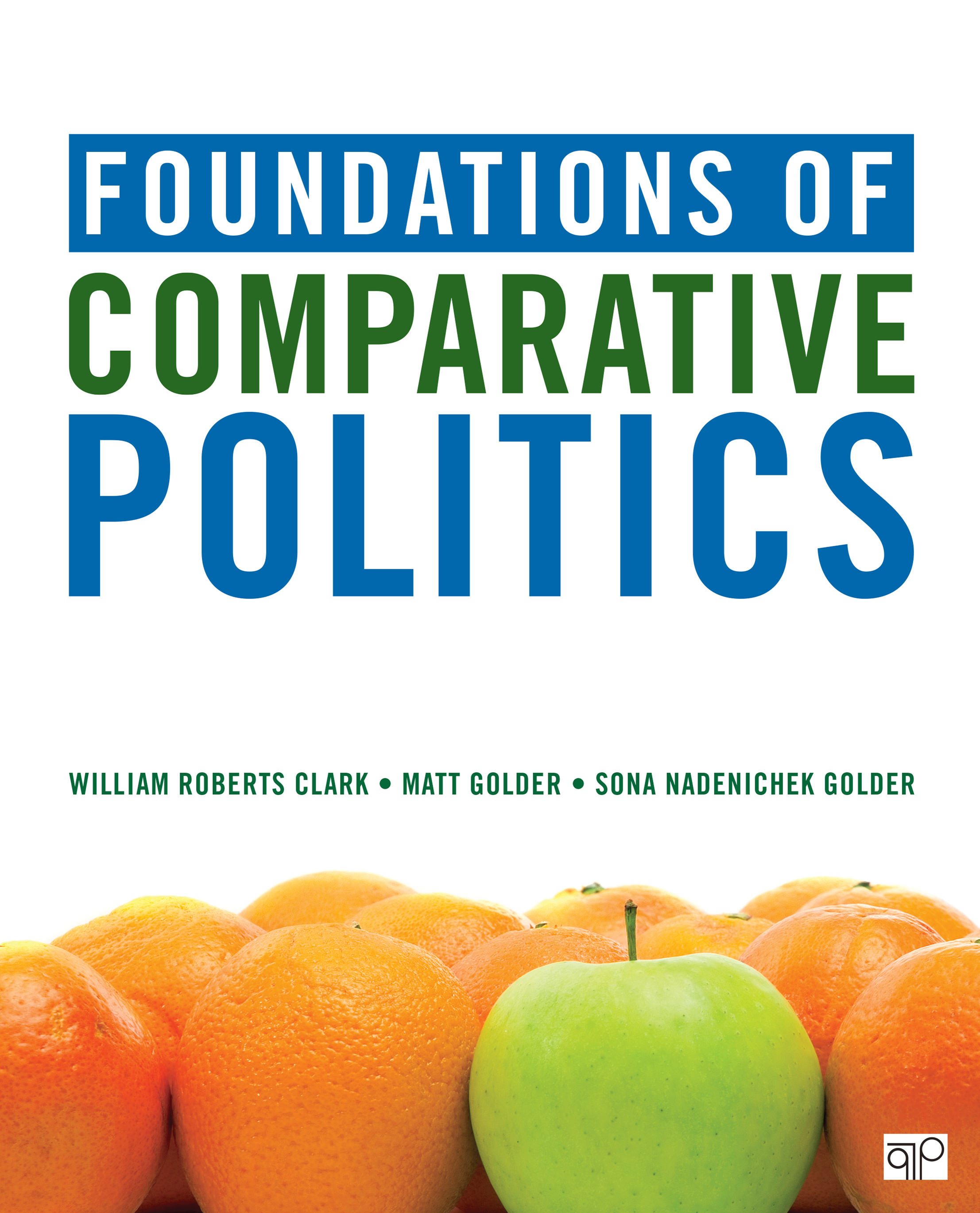
Foundations of Comparative Politics Adapted from the groundbreaking bestseller Principles of Comparative Politics, Third Edition! Foundations of Comparative Politics presents a scientific approach to the rich world of comparative inquiry, research, and scholarship, providing you a guide to cross-national comparison and why it matters. This condensed, more accessible format introduces you to the key questions in comparative politics, using brief insights from tools such as decision, social choice, and game theory to help you understand clearly why some explanations for political phenomena are stronger than others. Foundations concentrates on describing the core features of regimes and institutions and on analyzing how these fundamental attributes drive variation in the economic and political outcomes we care about most. This approach more closely replicates what comparative scholars do: constructing and testing theories on political phenomena over basic memorization of country-specific facts—to explain, rather than describe. Illustrated with current examples that show the application of theory, you will gain invaluable real-world skills in critical thinking and empirical analysis that you will carry with you long after the course is over. POLITICAL SCIENCE,Comparative Politics

Which Country Has the World's Best Health Care? The preeminent doctor and bioethicist Ezekiel Emanuel is repeatedly asked one question: Which country has the best healthcare? He set off to find an answer. The US spends more than any other nation, nearly $4 trillion, on healthcare. Yet, for all that expense, the US is not ranked #1 -- not even close. In Which Country Has the World's Best Healthcare? Ezekiel Emanuel profiles eleven of the world's healthcare systems in pursuit of the best or at least where excellence can be found. Using a unique comparative structure, the book allows healthcare professionals, patients, and policymakers alike to know which systems perform well, and why, and which face endemic problems. From Taiwan to Germany, Australia to Switzerland, the most inventive healthcare providers tackle a global set of challenges -- in pursuit of the best healthcare in the world. POLITICAL SCIENCE,Comparative Politics

Introducing Comparative Politics Introducing Comparative Politics: The Essentials is focused on core concepts and the big picture questions in comparative politics—Who rules? What explains political behavior? Where and why? Stephen Orvis and Carol Ann Drogus demonstrate the strengths and weaknesses of commonly debated theories, structures, and beliefs and push students to apply their understanding. While detailed case studies can go in-depth on specific countries and political systems, this book distills its country material into the narrative, increasing global awareness, current-event literacy, and critical-thinking skills. Adapted from the authors’ Introducing Comparative Politics, Fifth Edition, The Essentials version offers the same framework for understanding comparative politics in a briefer format, allowing you to teach the course the way you want to teach it. POLITICAL SCIENCE,Comparative Politics

Introducing Comparative Politics Organized thematically around important questions in comparative politics—who rules? what explains political behavior? where and why?—Introducing Comparative Politics, Fifth Edition, integrates a set of extended case studies of 11 countries that vividly illustrate issues in cross-national context. Serving as touchstones, the cases are placed within the chapters where they make the most sense —not separated from the theory or in a separate volume—helping students make connections between the two earlier in the semester. The book’s hybrid organization gives students a more holistic view of comparative politics. POLITICAL SCIENCE,Comparative Politics

The making of Thatcherism The making of Thatcherism examines the Conservative Party’s period in opposition between 1974 and 1979, focusing on the development of key policy on issues from the economy, to immigration and Scottish Devolution. Offering a detailed analysis of Conservative Party policy during this period, from the point at which it had last been in government to the point at which it subsequently regained power, this book helps us to understand the significance of the Conservative victory in 1979: What exactly did more than 13 million Britons vote for in May of that year?This period is typically viewed as one of dramatic change within the Conservative Party; however, Philip Begley argues that policy changes were more modest and complex than has been previously considered. Focusing on the short-term political context, Begley contends that though the roots of Thatcherism were beginning to emerge in the party, Thatcherism does not appear to have been inevitable in policy terms by 1979. Providing an overview of the intellectual, economic, and social contexts, this book examines the range of factors driving the Conservative Party’s development of policy. POLITICAL SCIENCE,Comparative Politics
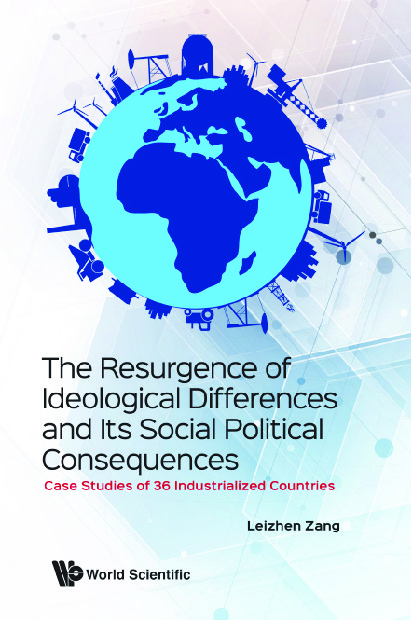
Resurgence Of Ideological Differences And Its Social Political Consequences, The This book is devoted to the analysis of ideological turnover and its social political consequences in 36 industrialized countries. The book pursues three major objectives. Firstly, it accurately proposes novel approaches to measure the impact of party ideologies on political efficiency, which fills the gap of current research that we lack effective methods to elucidate the degree of party conflicts between the cabinet and the parliament. Secondly, it analyzes the short-term or long-term impact of political turnover on government effectiveness and economic fluctuations, which has long been deemed as a complex and difficult problem. Thirdly, it illustrates the influences of political parties' left-right ideology on social security policy and workers' strikes, and verifies whether the lag-effects exist in social movements. This book helps readers understand the political turnover and effectively respond to shifts in politics and society. POLITICAL SCIENCE,Comparative Politics
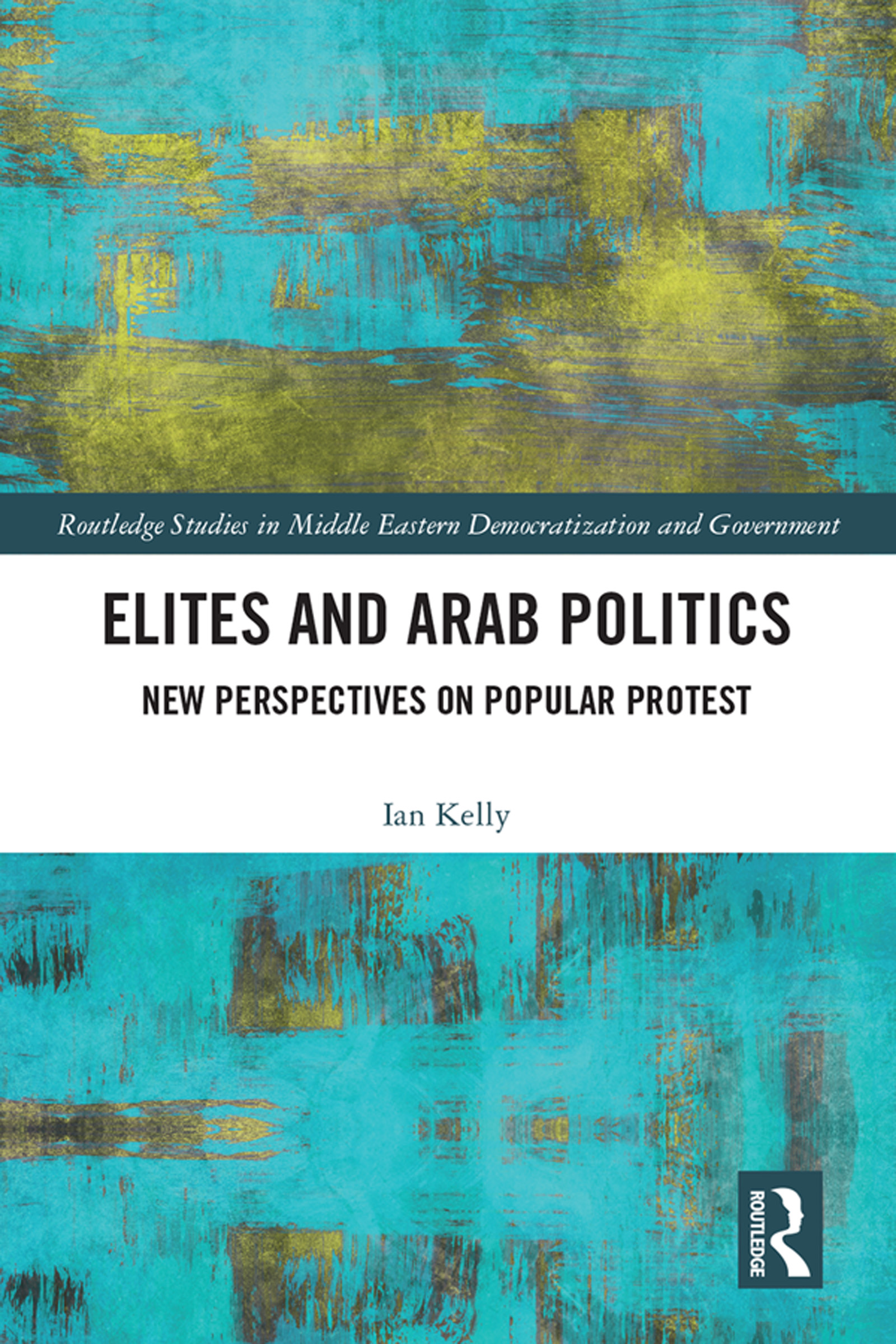
Elites and Arab Politics This work explains elite behaviour in authoritarian systems and proposes why elites withdraw their support for the incumbent when faced with popular uprisings. Building upon foundations drawn from institutional authoritarianism and synthesised with local context from the substantial scholarship on the Middle East and North Africa, the book argues that the elite supporting autocrats come from three distinct cadres: the military, the single-party and the personalist. Each of these cadres possesses its own distinct institutional interests and preferences towards regime change. Drawing on these interests, the study constructs a theoretical framework that is assessed through testing it against three variables. Utilising an analytic narrative, the research finds that the withdrawal of elite support is the consequence of long-term processes that see distinct cadres marginalised. First, increased incumbent preference for personalist elements destabilises regimes as the military and single-party cadres reconsider their positions. Second, neoliberal economic policies, implemented via structural adjustment, accelerated this personalisation as the state’s withdrawal from the economy. This, in turn, affected the ability of the military and single-party elites to access patronage. Finally, the degree of military involvement in the formal political sphere contributes to shaping the nature of the system that replaced the incumbent regime under examination. Building upon a wide range of literature the book argues that interest realisation determines whether or not elite actors support regime change in authoritarian systems. The volume will be of interest to scholars researching politics, social sciences and the Middle East. POLITICAL SCIENCE,Comparative Politics
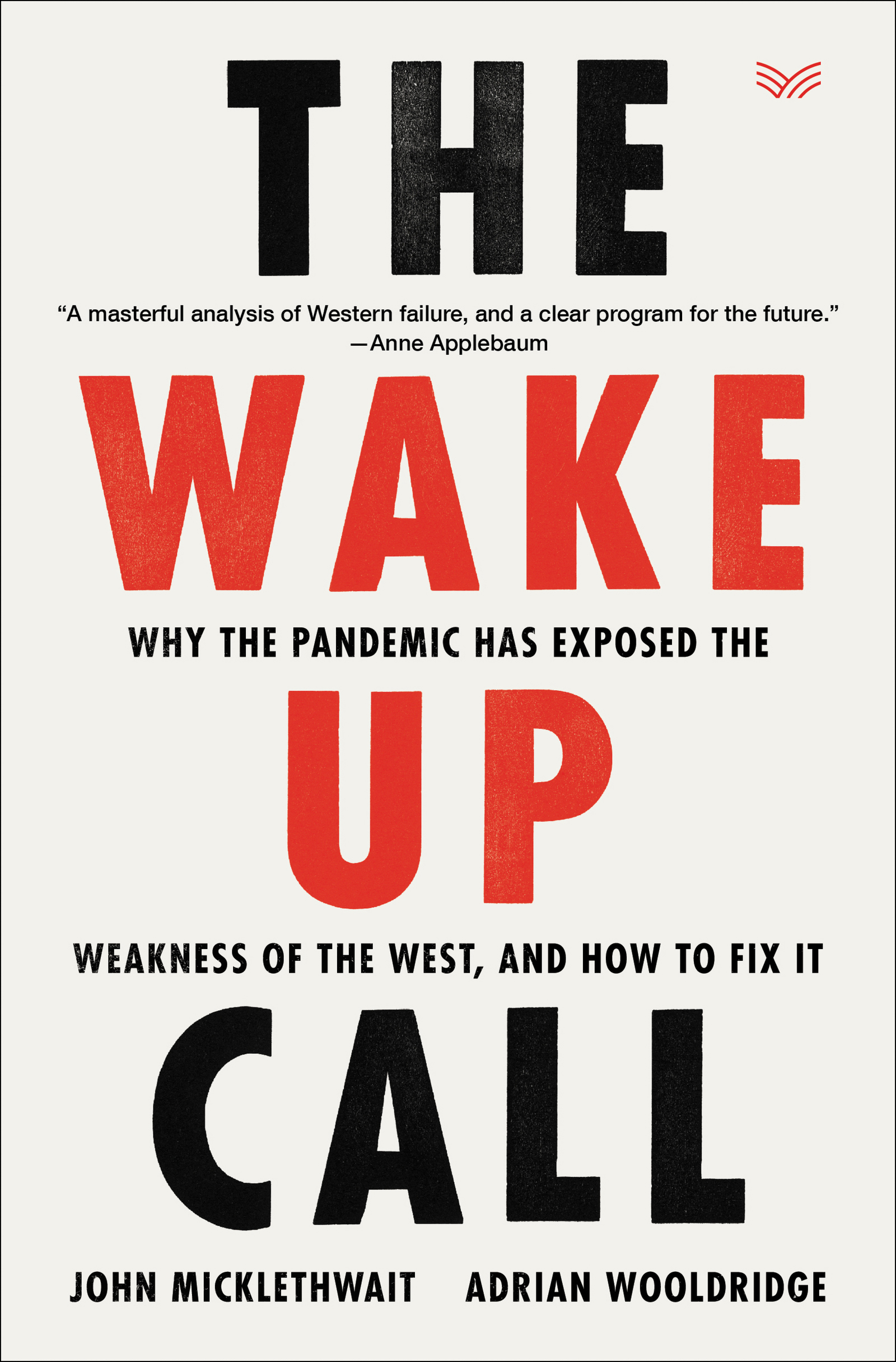
The Wake-Up Call An urgent and informed look at the challenges America and world governments will face in a post Covid-19 world. The Covid-19 pandemic has revealed that governments matter again, that competent leadership is the difference between living and dying. A few governments proved adept at handling the crisis while many others failed. Are Western governments healthy and strong enough to keep their citizens safe from another virulent virus—and protect their economies from collapse? Is global leadership passing from the United States to Asia—and particularly China? The Wake-Up Call addresses these urgent questions. Journalists and longtime collaborators John Micklethwait and Adrian Wooldridge identify the problems Western leaders face, and outline a detailed plan to help them become more vigilant, better prepared, and responsive to disruptive future events. The problems that face us are enormous; as The Wake-Up Call makes clear, governments around the world must re-engineer the way they operate to successfully meet the challenges ahead. POLITICAL SCIENCE,Comparative Politics
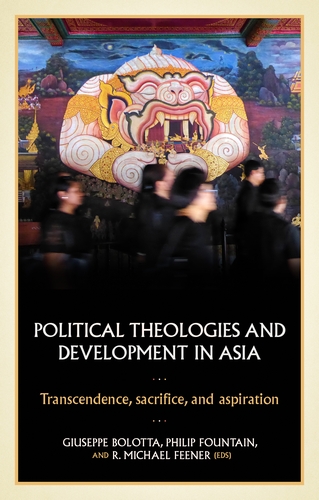
Political theologies and development in Asia A timely reassessment of the critical potential for political theology, this volume expands beyond the tendency to focus on the (post-)Christian West to open new lines of investigation. Through detailed empirical studies of development in Asia the chapters cast new light on the entanglements between religion and politics in this diverse region. POLITICAL SCIENCE,Comparative Politics

The Declaration of Independence and the United States Constitution What is the President, Congress, and the Supreme Court really allowed to do? This unique and handy guide includes the documents that guide our government, annotated with accessible explanations from one of America's most esteemed constitutional scholars. In one portable volume, with accessible annotations and modernizing commentary throughout, Richard Beeman presents The Declaration of Independence and the United States Constitution . Beeman has created a fascinating apparatus for understanding the most important document in American history—and why it’s as central in the America of today as it was in creation of the country. Penguin presents a series of six portable, accessible, and—above all—essential reads from American political history, selected by leading scholars. Series editor Richard Beeman, author of The Penguin Guide to the U.S. Constitution, draws together the great texts of American civic life to create a timely and informative mini-library of perennially vital issues. Whether readers are encountering these classic writings for the first time, or brushing up in anticipation of the 50th anniversary of the Civil Rights Act, these slim volumes will serve as a powerful and illuminating resource for scholars, students, and civic-minded citizens. POLITICAL SCIENCE,Constitutions

The Citizen's Constitution Pocket versions of the Constitution of the United States of America abound, as do multi-volume commentaries, scholarly histories of its writing, and political posturings of various clauses. But what if you want a delightfully quick, witty, and readable reference that, in one compact volume, places the document and its clauses into context? You're out of luck -- until now. Written by Seth Lipsky, described in the Boston Globe as "a legendary figure in contemporary journalism,&" The Citizen's Constitution draws on the writings of the Founders, case law from our greatest judges, and current events in more than 300 illuminating annotations. Lipsky provides a no-nonsense, entertaining, and learned guide to the fundamental questions surrounding the document that governs how we govern our country. Every American should know the Constitution. Rarely has it glinted so brightly. POLITICAL SCIENCE,Constitutions

Constitution The Constitution introduces students to the Preamble, the Articles of the Constitution, and the Amendments that followed. The activities will help students explore why the Constitution was needed in the first place and what arguments and compromises were made in order to make it happen. Students will meet the signers of the document and learn about the process they went through to draft the final version. Activites include games, interpreting political cartoons, vocabulary, constructing a time line and government tree. POLITICAL SCIENCE,Constitutions

A Pocket Guide to the US Constitution The Constitution is not so simple that it explains itself—nor so complex that only experts can understand it. In this accessible, nonpartisan quick reference, historian Andrew Arnold provides concise explanations of the Constitution's meaning and history, offering little-known facts and anecdotes about every article and all twenty-seven amendments. This handy guide won’t tell you what the Constitution ought to say, nor what it ought to mean. It will tell you what the Constitution says and what it has meant. A Pocket Guide to the US Constitution presents a straightforward way to understand the American Constitutional system. Without wading through lengthy legal prose, heavy historical analysis, or polemical diatribes, you can easily find out what the emoluments clause means, learn about gerrymandering and separation of powers, or read a brief background on why slaves in colonial America were considered 3/5 of a person. Small enough to put in your pocket, backpack, or briefcase, A Pocket Guide to the US Constitution can be used to comprehend current events, dig deeper into court cases, or sort out your own opinions on constitutional issues. POLITICAL SCIENCE,Constitutions

How to Read the Constitution--and Why "A must-read for this era.â€â€”Jake Tapper, CNN Anchor and Chief Washington Correspondent An insightful, urgent, and perennially relevant handbook that lays out in common sense language how the United States Constitution works, and how its protections are eroding before our eyes—essential reading for anyone who wants to understand and parse the constantly breaking news about the backbone of American government. The Constitution is the most significant document in America. But do you fully understand what this valuable document means to you? In How to Read the Constitution--and Why, legal expert and educator Kimberly Wehle spells out in clear, simple, and common sense terms what is in the Constitution, and most importantly, what it means. In compelling terms and including text from the United States Constitution, she describes how the Constitution’s protections are eroding—not only in express terms but by virtue of the many legal and social norms that no longer shore up its legitimacy—and why every American needs to heed to this “red flag†moment in our democracy. This invaluable—and timely—resource includes the Constitution in its entirety and covers nearly every significant aspect of the text, from the powers of the President and how the three branches of government are designed to hold each other accountable, to what it means to have individual rights—including free speech, the right to bear arms, the right to be free from unreasonable searches and seizures, and the right to an abortion. Finally, the book explains why it has never been more important than now for all Americans to know how our Constitution works—and why, if we don’t step in to protect it now, we could lose its protections forever. How to Read the Constitution--and Why is essential reading for anyone who cares about maintaining an accountable government and the individual freedoms that the Constitution enshrines for everyone in America—regardless of political party. POLITICAL SCIENCE,Constitutions
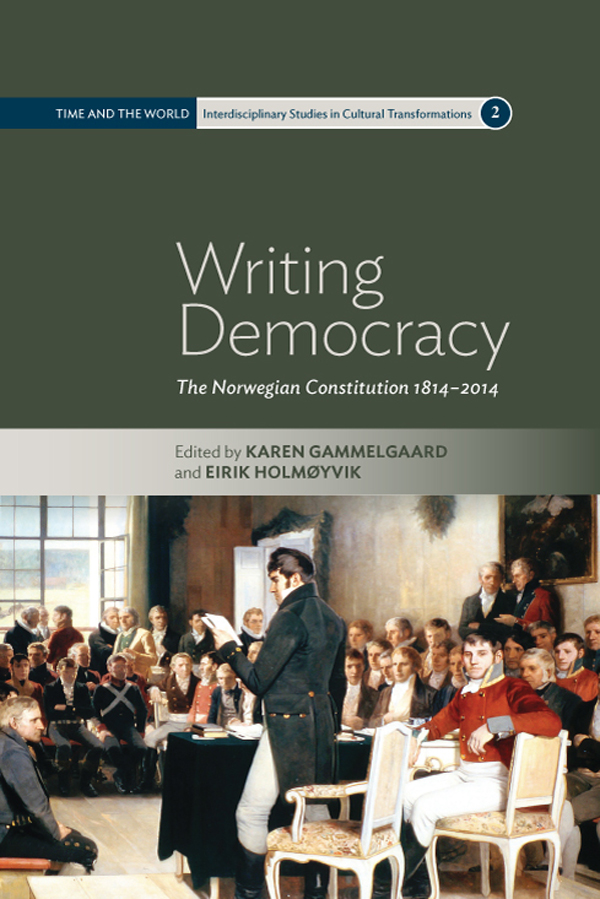
Writing Democracy The Norwegian Constitution is the oldest functioning constitution in Europe. Its bicentenary in 2014 has inspired the analyses in this volume, where contributors focus on the Constitution as a text to explore new ways of analyzing democratic development. This volume examines the framing of the Norwegian Constitution, its transformations, and its interpretations during the last two centuries. The textual focus enables new understandings of the framers’ negotiations and decisions on a democratic micro level and opens new international and historical contexts to understanding the Norwegian Constitution. By synthesizing knowledge from different realms - law, social sciences, and the humanities – Writing Democracy provides a model for examining the distinct textual qualities of constitutional documents. POLITICAL SCIENCE,Constitutions

Armed in America NOW WITH A NEW PREFACE THAT BRINGS THE FRAUGHT GUN-RIGHTS CONTROVERSY UP TO DATEThis accessible legal history describes the way in which the Second Amendment was interpreted throughout most of American history and shows that today's gun-rights advocates have drastically departed from the long-held interpretation of the right to bear arms.This illuminating study traces the transformation of the right to arms from its inception in English and colonial American law to today's impassioned gun-control debate. As historian and legal scholar Patrick J. Charles shows, what the right to arms means to Americans, as well as what it legally protects, has changed drastically since its first appearance in the 1689 Declaration of Rights.Armed in America explores how and why the right to arms transformed at different points in history. The right was initially meant to serve as a parliamentary right of resistance, yet by the ratification of the Second Amendment in 1791 the right had become indispensably intertwined with civic republicanism. As the United States progressed into the 19th century the right continued to change--this time away from civic republicanism and towards the individual-right understanding that is known today, albeit with the important caveat that the right could be severely restricted by the government's police power. Throughout the 20th century this understanding of the right remained the predominant view. But working behind the scenes was the beginnings of the gun-rights movement--a movement that was started in the early 20th century through the collective efforts of sporting magazine editors and was eventually commandeered by the National Rifle Association to become the gun-rights movement known today.Now with a new preface that brings the fraught gun-rights controversy up to date, this book is an invaluable resource for readers looking to sort through the shrill rhetoric surrounding the current gun debate and arrive at an informed understanding of the legal and historical development of the right to arms. POLITICAL SCIENCE,Constitutions

Modern Constitutions The world has seen many new constitutions promising social rights and adopting innovative representative institutions. This book presents examples from the United States, Europe, Africa, and Asia that show these constitutions face many challenges, especially the rise of authoritarian regimes that endanger the rule of law. POLITICAL SCIENCE,Constitutions

Shall Not Be Infringed Shall Not be Infringed: The New Assaults on Your Second Amendment is a history of the relatively short gun control debate in America and a revealing description of how those hostile to the Second Amendment use polls, studies, and numbers to confuse the public. Expert pro-gun advocates David Keene and Thomas Mason tell the story of the battle fought in the courts, Congress, and state legislatures across the country as well as in the media and even the United Nations. Guns have become a symbol over which battle after battle is fought, all the while hiding the end game of a cultural shift to government dominance. Although the Supreme Court ruled the Second Amendment guarantees an individual right to keep and bear arms,†candidate Clinton and the Democratic Party have promised to pick Supreme Court justices who will overturn this ruling. Gun control advocates insist the Court was wrong and a new Court should reverse that finding, stripping American gun owners of the Constitutional protection that has thus far made it impossible to ban gun ownership. Addressing vital issues such as deterring and preventing crime, troubling presidential and Congressional politics, problematic anti-gun proposals, and so much more, Shall Not Be Infringed is an essential read for our times. POLITICAL SCIENCE,Constitutions

The Oath and the Office “A cleareyed, accessible, and informative primer: vital reading for all Americans.â€â€”Kirkus Reviews, starred review Can the president launch a nuclear attack without congressional approval? Is it ever a crime to criticize the president? Can states legally resist a president’s executive order? In today’s fraught political climate, it often seems as if we must become constitutional law scholars just to understand the news from Washington, let alone make a responsible decision at the polls. The Oath and the Office is the book we need, right now and into the future, whether we are voting for or running to become president of the United States. Constitutional law scholar and political science professor Corey Brettschneider guides us through the Constitution and explains the powers—and limits—that it places on the presidency. From the document itself and from American history’s most famous court cases, we learn why certain powers were granted to the presidency, how the Bill of Rights limits those powers, and what “we the people†can do to influence the nation’s highest public office—including, if need be, removing the person in it. In these brief yet deeply researched chapters, we meet founding fathers such as James Madison and Alexander Hamilton, as well as key figures from historic cases such as Brown v. Board of Education and Korematsu v. United States. Brettschneider breathes new life into the articles and amendments that we once read about in high school civics class, but that have real impact on our lives today. The Oath and the Office offers a compact, comprehensive tour of the Constitution, and empowers all readers, voters, and future presidents with the knowledge and confidence to read and understand one of our nation’s most important founding documents. POLITICAL SCIENCE,Constitutions

Inside the NRA A shocking exposé of rampant, decades-long incompetence at the National Rifle Association, as told by a former member of its senior leadership. Joshua L. Powell is the NRA--a lifelong gun advocate, in 2016, he began his new role as a senior strategist and chief of staff to NRA CEO Wayne LaPierre. What Powell uncovered was horrifying: "the waste and dysfunction at the NRA was staggering." INSIDE THE NRA reveals for the first time the rise and fall of the most powerful political organization in America--how the NRA became feared as the Death Star of Washington lobbies and so militant and extreme as "to create and fuel the toxicity of the gun debate until it became outright explosive." INSIDE THE NRA explains this intentional toxic messaging was wholly the product of LaPierre's leadership and the extremist branding by his longtime PR puppet master Angus McQueen. In damning detail, Powell exposes the NRA's plan to "pour gasoline" on the fire in the fight against gun control, to sow discord to fill its coffers, and to secure the presidency for Donald J. Trump. POLITICAL SCIENCE,Constitutions

Who Really Runs Ireland? The story of the elite who led Ireland from bust to boom ... and back to bust again Having money and not having it; making it and losing it; using it and misusing it; giving it and taking it ... this is the story of Ireland during the boom, described in jaw-dropping detail in Who Really Runs Ireland? Leading journalist Matt Cooper identifies the most influential people in Ireland during the Celtic Tiger era, describes how they interacted with each other to mutual benefit, and reveals who were the few to retain their power amid the debris arising from the bursting of the Irish economic bubble. 'Highly accessible and akin to a good thriller ... fascinating ... compelling' Sunday Tribune 'Hugely entertaining as well as instructive' Irish Independent 'Impressive and eminently readable' Irish Times 'An eye-opener ... you might be driven to tears of rage' David McCullagh, RTE 'The detail is riveting ... and a lot of it illuminating'Irish Examiner 'The scale of Cooper's research is highly impressive ... an in-depth reference guide to folly and hubris' Sunday Business Post 'Complex but surprisingly reader-friendly ... a rattling, and frequently horrifying, read' Hot Press 'Superbly readable and insightful ... a must-have' Irish Mail on Sunday POLITICAL SCIENCE,Corruption & Misconduct

The Untouchables A devastating new exposé from the bestselling authors of The Bankers and Wasters. In March 2011, the Irish people elected a new government. But how much had really changed? In The Untouchables, Shane Ross and Nick Webb shine a light into dark corners of official Ireland to show that the blame for running the country into the ground goes well beyond Fianna Fáil, and that a dismaying number of the people who should share the blame are still in situ: in the civil service, on the boards of the leading companies, and in the banks, law firms, and consultancies that carry so much influence in deciding who wins and who loses. They name names, trace connections, and show how the untouchables managed to do so much damage, how they got away with it, and how so many of them are still in positions of power and influence in Ireland. 'Fascinating ... required reading for anyone interested in how crony capitalism and power work in practice in Ireland' Irish Times 'The Untouchables is hard to put down. Read it and seethe.' Irish Independent Shane Ross is an independent TD for Dublin South, and columnist in the Sunday Independent. Nick Webb is business editor of the Sunday Independent. They are the authors of Wasters, 2010's top-selling Irish current affairs title. POLITICAL SCIENCE,Corruption & Misconduct

Watergate Here is the definitive history of the Watergate scandal—based on the most recently released tapes, in-depth interviews with many of the participants, and hundreds of official and unofficial documents, including notes Haldeman omitted from his own published diaries. Emery's comprehensive coverage and penetrating insights clear up many uncertainties that may still remain about the scandal and the extent of Nixon's involvement. Authoritative and compelling, Watergate is essential reading for anyone who wants to understand fully this traumatizing episode in America's history that challenged the integrity of its political system. POLITICAL SCIENCE,Corruption & Misconduct

The Wars of Watergate This is the first truly comprehensive history of the political explosion that shook America in the 1970s, and whose aftereffects are still being felt in public life today. Drawing on contemporary documents, personal interviews, memoirs, and a vast quantity of new material, Stanley Kutler shows how President Nixon’s obstruction of justice from the White House capped a pattern of abuse that marked his entire tenure in office. He makes clear how the drama of Watergate is rooted not only in the tumultuous events and social tensions of the 1960s but also in the personality and history of Richard Nixon. Kutler examines Nixon’s confrontations with the institutions he feared and resented—the Congress, the federal agencies, the news media, the Washington establishment—and how they mobilized to topple the President. He considers the arguments of Nixon’s defenders, who insisted that Watergate was a minor affair, and the contention that the President did nothing worse than his predecessors had done. He offers compelling portraits of the President’s men—H. R. Haldeman, John Ehrlichman, John Mitchell, Charles Colson, John Dean; of his adversaries—Judge John Sirica, the U.S. Attorneys, Special Prosecutors Archibald Cox and Leon Jaworski; and of the legislators who would stand in judgment—Sam Ervin and Peter Rodino. In the course of his engrossing narrative, Stanley Kutler illuminates the constitutional crisis brought on by Watergate. He shows how Watergate diminished the moral level of American political life, and illustrates its continuing detrimental impact on the credibility, authority, and prestige of the Presidency in particular and the government in general. His book underlines for the American electorate the significance of Watergate for the future of our political ethics and the maintenance of our constitutional system, as well as for the place of Richard Nixon in American history. POLITICAL SCIENCE,Corruption & Misconduct
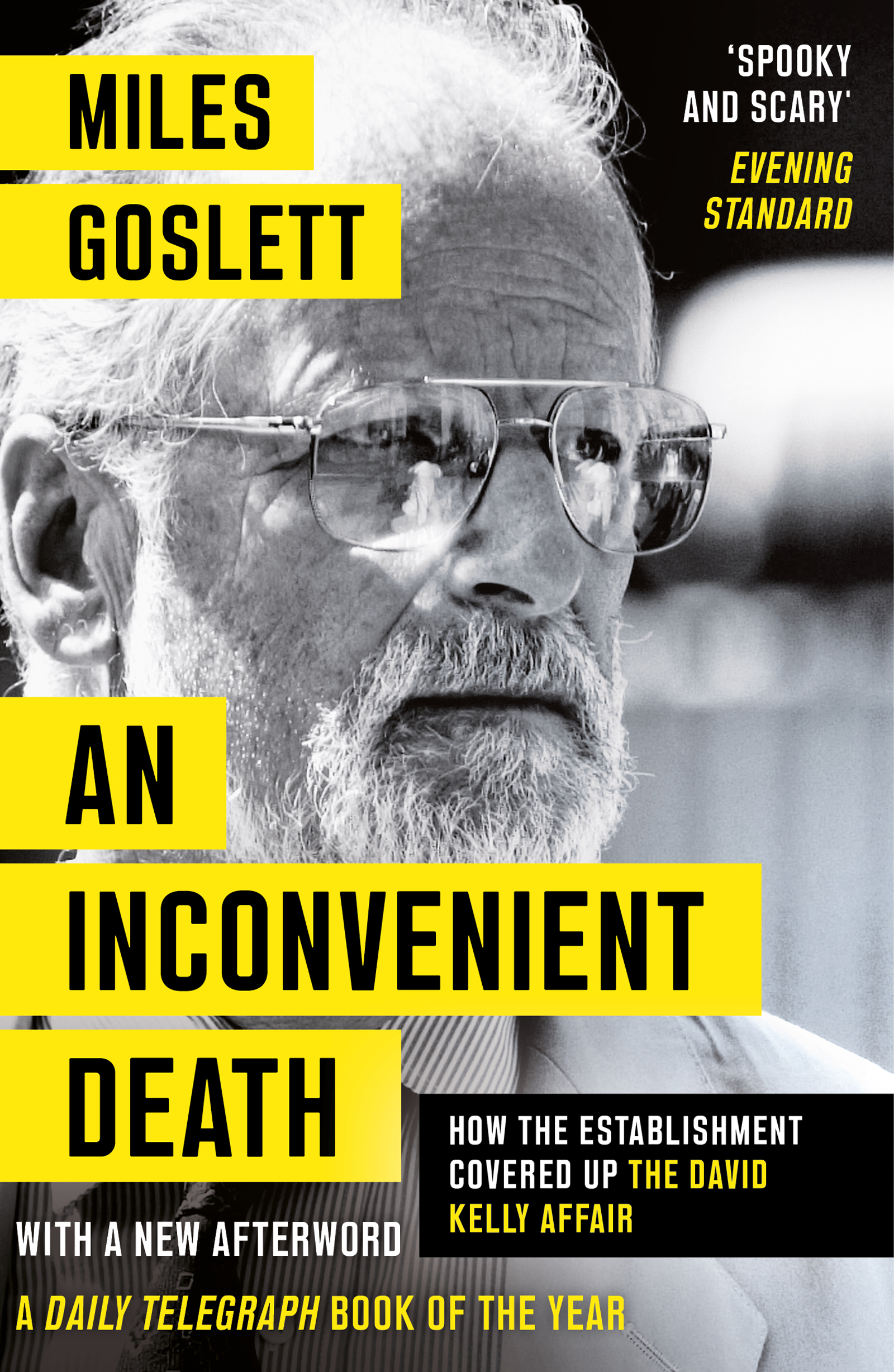
An Inconvenient Death The examination of one of the most mysterious episodes in recent British political history by a renowned investigative journalist. POLITICAL SCIENCE,Corruption & Misconduct

Bertie Ahern The fascinating story of the man who blew the boom. Colm Keena, the journalist who first broke the story of Bertie Ahern's finances, gives us an in-depth examination of the former Taoiseach's character, his lust for power and his obsession with money. Keena scrutinises the evidence produced by the Mahon Tribunal about Ahern's personal finances and his personal political machine, and illustrates the lengths to which Ahern went in his effort to hide the truth about what he was up to. Ahern's political career is re-charted in the light of what we now know about his character. Keena looks at how his desire for power existed alongside an almost complete absence of political conviction, this lack of which left him open to the influence of those with strong opinions, and did nothing to arrest his mismanagement of the Irish economy. His lust for popularity brought Ireland from rude good health to economic disaster. An historic opportunity was squandered, but Bertie walked away from the wreckage with his wallet bulging. His legacy: the near-destruction of a European economy and the collapse of one of the most successful political parties of the past hundred years. POLITICAL SCIENCE,Corruption & Misconduct

Silent No More As seen on Tucker Carlson Tonight, Hannity, and CNN! In Silent No More: How I Became a Political Prisoner of Mueller’s “Witch Huntâ€, New York Times bestselling author of Killing the Deep State Jerome R. Corsi, Ph.D. meticulously details the psychological torment he was subjected to in what the media has simply called, “The Mueller Investigation.†In late 2018, in an FBI closed conference room with no windows, Dr. Corsi was confronted for hours upon hours at a time by detailed questioning about events that occurred in 2016. Dr. Corsi’s inquisition was worthy of the Gestapo or KGB, designed to break even the most cooperating witness. Over a period of two months, three of Mueller’s top prosecutors and an army of FBI agents—up to nine government officials at a time—questioned Dr. Corsi with his attorney, David Gray. Throughout this harrowing ordeal, Dr. Corsi handed over his personal computers, his cell phone, all of his email accounts, his Twitter account, and his Google account. Finding no “smoking gun,†Mueller’s prosecutors blew up the meetings. Dr. Corsi refused to lie to the prosecutors to give them the ammunition they needed to prosecute Roger Stone, and as a result he was told he would be charged with a criminal offense for lying to the FBI and the Special Prosecutor. At seventy-two years of age, Dr. Corsi was subjected to extreme mental anguish, imagining that he may never see his family again as a free man. Rather than conducting an honest investigation, Mueller’s Special Prosecutors reinforced a prefabricated narrative aiming to charge President Trump with Treason. Silent No More: How I Became a Political Prisoner of Mueller’s "Witch Hunt" exposes the inner workings of this governmental escapade, and clearly states why Mueller has no case against the President. Dr. Corsi creates a compelling case indicating that the entire matter is an investigation in search of a crime—to force lying testimony from witnesses if that’s what it takes to achieve Deep State political objectives. POLITICAL SCIENCE,Corruption & Misconduct
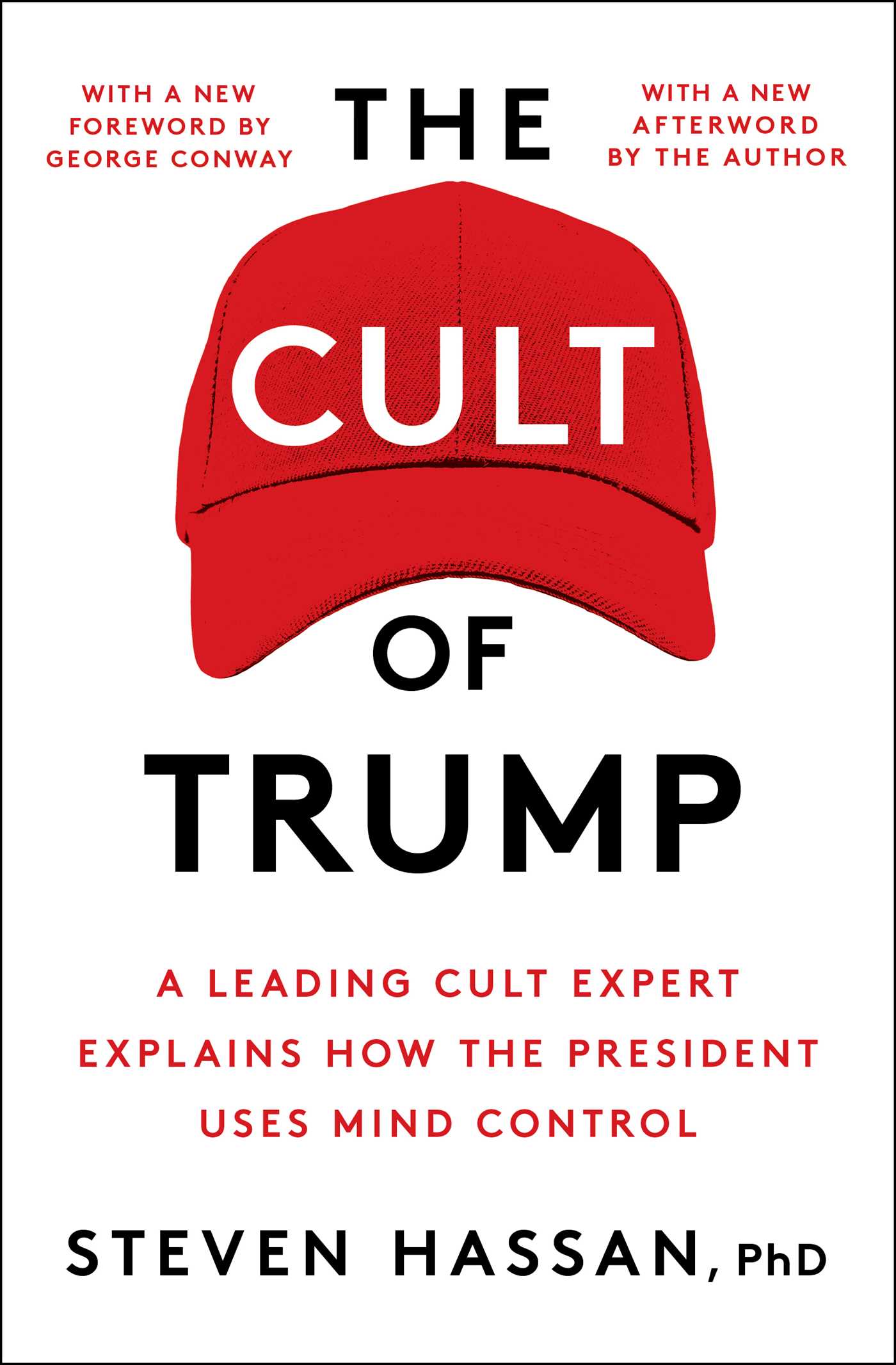
The Cult of Trump A masterful and eye-opening examination of Trump and the coercive control tactics he uses to build a fanatical devotion in his supporters written by “ an authority on breaking away from cults…an argument that…bears consideration as the next election cycle heats up†(Kirkus Reviews). Since the 2016 election, Donald Trump’s behavior has become both more disturbing and yet increasingly familiar. He relies on phrases like, “fake news,†“build the wall,†and continues to spread the divisive mentality of us-vs.-them. He lies constantly, has no conscience, never admits when he is wrong, and projects all of his shortcomings on to others. He has become more authoritarian, more outrageous, and yet many of his followers remain blindly devoted. Scott Adams, the creator of Dilbert and a major Trump supporter, calls him one of the most persuasive people living. His need to squash alternate information and his insistence of constant ego stroking are all characteristics of other famous leaders—cult leaders. In The Cult of Trump, mind control and licensed mental health expert Steven Hassan draws parallels between our current president and people like Jim Jones, David Koresh, Ron Hubbard, and Sun Myung Moon, arguing that this presidency is in many ways like a destructive cult. He specifically details the ways in which people are influenced through an array of social psychology methods and how they become fiercely loyal and obedient. Hassan was a former “Moonie†himself, and he presents a “thoughtful and well-researched analysis of some of the most puzzling aspects of the current presidency, including the remarkable passivity of fellow Republicans [and] the gross pandering of many members of the press†(Thomas G. Gutheil, MD and professor of psychiatry, Harvard Medical School). The Cult of Trump is an accessible and in-depth analysis of the president, showing that under the right circumstances, even sane, rational, well-adjusted people can be persuaded to believe the most outrageous ideas. “This book is a must for anyone who wants to understand the current political climate†(Judith Stevens-Long, PhD and author of Living Well, Dying Well). POLITICAL SCIENCE,Corruption & Misconduct

Hidden History The US government has spent as much time covering up conspiracies as it has helping the American people. In Hidden History, you will see the amount of effort that our government has dedicated over the past fifty years to lying and covering up the truth to the world. Starting with the assassination of President John F. Kennedy, Don Jeffries chronicles a wide variety of issues that have plagued our country's history. Whether it is the assassinations of MLK and RFK, Iran-Contra, the Oklahoma City bombing, TWA Flight 800, voting fraud, or 9/11, every major disaster or war that we've sitnessed has somehow been distorted by those who are supposed to be protecting us. Jeffries also delves into extensive research on the death of John F. Kennedy, Jr. - and what he finds will shock you. So whether you've only heard bits and pieces of these stories or you've read several books on the topics, Hidden History is the book that belongs in every conspiracy theorist's library, as the information included here has never been collected together in any other published work available. So sit down, strap in, and get ready to be shocked and awed by how much has been hidden by our government over the past fifty years. Updated for 2016, this version features a new introduction by political insider Roger Stone. POLITICAL SCIENCE,Corruption & Misconduct

The Burn Pits “There’s a whole chapter on my son Beau… He was co-located [twice] near these burn pits.†–Joe Biden, former Vice President of the United States of America The Agent Orange of the 21st Century… Thousands of American soldiers are returning from the battlefields of Iraq and Afghanistan with severe wounds from chemical war. They are not the victims of ruthless enemy warfare, but of their own military commanders. These soldiers, afflicted with rare cancers and respiratory diseases, were sickened from the smoke and ash swirling out of the “burn pits†where military contractors incinerated mountains of trash, including old stockpiles of mustard and sarin gas, medical waste, and other toxic material. This shocking work, now for the first time in paperback, includes: Illustration of the devastation in one soldier’s intimate story A plea for help Connection between the burn pits and Major Biden’s unfortunate suffering and death The burn pits’ effects on native citizens of Iraq: mothers, fathers, and children Denial from the Department of Defense and others Warning signs that were ignored and much more Based on thousands of government documents, over five hundred in-depth medical case studies, and interviews with more than one thousand veterans and active-duty GIs, The Burn Pits will shock the nation. The book is more than an explosive work of investigative journalism—it is the deeply moving chronicle of the many young men and women who signed up to serve their country in the wake of 9/11, only to return home permanently damaged, the victims of their own armed forces’ criminal negligence. POLITICAL SCIENCE,Corruption & Misconduct

Plunder of the Commons 'One of the most important books I've read in years' Brian Eno We are losing the commons. Austerity and neoliberal policies have depleted our shared wealth; our national utilities have been sold off to foreign conglomerates, social housing is almost non-existent, our parks are cordoned off for private events and our national art galleries are sponsored by banks and oil companies. This plunder deprives us all of our common rights, recognized as far back as the Magna Carta and the Charter of the Forest of 1217, to share fairly and equitably in our public wealth. Guy Standing leads us through a new appraisal of the commons, stemming from the medieval concept of common land reserved in ancient law from marauding barons, to his modern reappraisal of the resources we all hold in common - a brilliant new synthesis that crystallises quite how much public wealth has been redirected to the 1% in recent decades through the state-approved exploitation of everything from our land to our state housing, health and benefit systems, to our justice system, schools, newspapers and even the air we breathe. Plunder of the Commons proposes a charter for a new form of commoning, of remembering, guarding and sharing that which belongs to us all, to slash inequality and soothe our current political instability. POLITICAL SCIENCE,Corruption & Misconduct

Crisis of Conscience "A call to arms and to action, for anyone with a conscience, anyone alarmed about the decline of our democracy." — New York Times-bestselling author Wendell Potter "Powerful...His extensively reported tales of individual whistleblowers and their often cruel fates are compelling...They reveal what it can mean to live in an age of fraud." — The Washington Post "Tom Mueller's authoritative and timely book reveals what drives a few brave souls to expose and denounce specific cases of corruption. He describes the structural decay that plagues many of our most powerful institutions, putting democracy itself in danger." —George Soros A David-and-Goliath story for our times: the riveting account of the heroes who are fighting a rising tide of wrongdoing by the powerful, and showing us the path forward. We live in a period of sweeping corruption -- and a golden age of whistleblowing. Over the past few decades, principled insiders who expose wrongdoing have gained unprecedented legal and social stature, emerging as the government's best weapon against corporate misconduct--and the citizenry's best defense against government gone bad. Whistleblowers force us to confront fundamental questions about the balance between free speech and state secrecy, and between individual morality and corporate power. In Crisis of Conscience, Tom Mueller traces the rise of whistleblowing through a series of riveting cases drawn from the worlds of healthcare and other businesses, Wall Street, and Washington. Drawing on in-depth interviews with more than two hundred whistleblowers and the trailblazing lawyers who arm them for battle--plus politicians, intelligence analysts, government watchdogs, cognitive scientists, and other experts--Mueller anatomizes what inspires some to speak out while the rest of us become complicit in our silence. Whistleblowers, we come to see, are the freethinking, outspoken citizens for whom our republic was conceived. And they are the models we must emulate if our democracy is to survive. POLITICAL SCIENCE,Corruption & Misconduct

The Mueller Report ONE OF TIME’S 100 BEST BOOKS OF THE YEAR The Crucial #1 New York Times Bestseller “The Mueller report is that rare Washington tell-all that surpasses its pre-publication hype…the best book by far on the workings of the Trump presidency.†—Carlos Lozada, The Washington Post The only book with exclusive analysis by the Pulitzer Prize–winning staff of The Washington Post, and the most complete and authoritative available. Read the findings of the Special Counsel’s investigation into Russian interference in the 2016 election, complete with accompanying analysis by the Post reporters who’ve covered the story from the beginning. This edition from The Washington Post/Scribner contains: —The long-awaited Report On The Investigation Into Russian Interference In The 2016 Presidential Election —An introduction by The Washington Post titled “A President, a Prosecutor, and the Protection of American Democracy†—A timeline of the major events of the Special Counsel’s investigation from May 2017, when Robert Mueller was appointed, to the report's delivery —A guide to individuals involved, including in the Special Counsel’s Office, the Department of Justice, the FBI, the Trump Campaign, the White House, the Trump legal defense team, and the Russians —Key documents in the Special Counsel’s investigation, including filings pertaining to General Michael T. Flynn, Paul Manafort, Michael Cohen, Roger Stone, and the Russian internet operation in St. Petersburg. Each document is introduced and explained by Washington Post reporters. One of the most urgent and important investigations ever conducted, the Mueller inquiry focuses on Donald Trump, his presidential campaign, and Russian interference in the 2016 election, and draws on the testimony of dozens of witnesses and the work of some of the country’s most seasoned prosecutors. The special counsel’s investigation looms as a turning point in American history. The Mueller Report is essential reading for all citizens concerned about the fate of the presidency and the future of our democracy. POLITICAL SCIENCE,Corruption & Misconduct

The Mueller Report NOW A NEW YORK TIMES, WASHINGTON POST, WALL STREET JOURNAL, USA TODAY, AND PUBLISHERS WEEKLY BESTSELLER. There has never been a more important political investigation than Robert S. Mueller III's into President Donald Trump's possible collusion with Russia. His momentous findings can be found here, complete with: The 300+ pages of the historic report, as released by the Justice Department An introduction by constitutional scholar, eminent civil libertarian, and New York Times bestselling author Alan Dershowitz. The relevant portions of Title 28 of the Code of Federal Regulations, the 1999 provisions written by former acting Solicitor General Neal Katyal, which establish and regulate the powers of the special counsel. Rod Rosenstein’s 2016 order appointing Robert Mueller III as special counsel and outlining the scope of his investigation. Attorney General William Barr’s four-page summary of the report, as sent to Congress. Barr's explanation of the four reasons for redacting the report, and a key for identifying them in the color-coded report The wait is over. Robert Mueller, a lifelong Republican, has concluded his investigation and submitted its findings to Attorney General William Barr. Barr has told Congress that Mueller found no proof of collusion between the Trump campaign and Russia, and did not come to a conclusion on obstruction of justice—neither concluding the president committed a crime nor exonerating him. But Mueller’s report was over 300 pages and Barr’s summary was only four pages, raising questions about the conclusions of a historic investigation. Special Counsel Robert Mueller III’s probe into Russian influence on the 2016 election of Donald Trump—including links between the campaign and Russian interests, obstruction of justice by President Trump, and any other matters that may have arisen in the course of the investigation—has been the focal point of American politics since its inception in May 2017. Democrats in the US House of Representatives hoped to use the report to begin impeachment proceedings, with the support of those critical of the president. Media tracked Mueller’s every move, and the investigation was subject to constant speculation by political pundits everywhere. It resulted in the indictments of Michael Flynn, Paul Manafort, Roger Stone, and many others. President Trump and his supporters affirmed that the investigation was a “witch hunt†and the product of a plot by the political establishment—the “deep stateâ€â€”to delegitimize his presidency. Mueller’s findings—at least according to Barr—allowed the latter to claim victory. But now, thanks to a subpoena from House Judiciary Committee chairman Jerry Nadler for the full report, a resolution from the House of Representatives to release the full report to the public (though blocked in the Senate by Mitch McConnell), and popular demand, it’s time for public to judge if that is true. The Mueller investigation will join Watergate, and the Mueller Report will join the 9/11 Commission Report, the Warren Report, and the Starr Report, as one of the most important in history. The Mueller Report is required reading for everyone with interest in American politics, for every 2016 and 2020 voter, and every American. It’s now available here as an affordable paperback, featuring an introduction from eminent civil libertarian, Harvard Law Professor Emeritus, and New York Times bestselling author Alan Dershowitz, who provides a constitutional, civil law-based commentary sorely needed in today’s media landscape. POLITICAL SCIENCE,Corruption & Misconduct
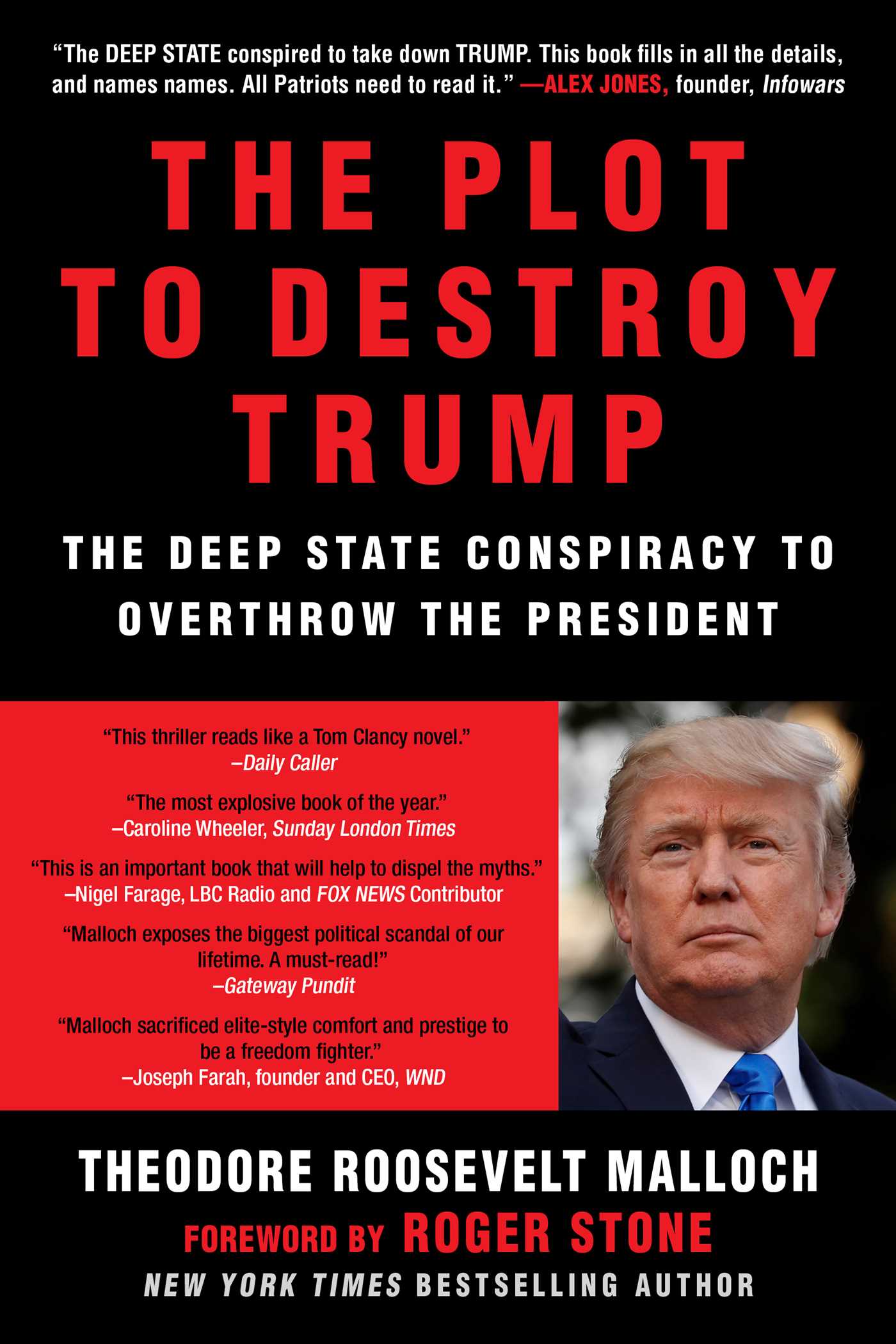
The Plot to Destroy Trump “The DEEP STATE conspired to take down TRUMP. This book fills in all the details, and names names. All Patriots need to read it.†Alex Jones, founder, Infowars With a new afterword, updated from its hardcover edition, The Plot to Destroy Trump exposes the deep state conspiracy to discredit and even depose the legitimately elected President Donald J. Trump with the fabricated Russian dossier, including: How the unsubstantiated accusations of collusion began with former MI6 agent Christopher Steele, Fusion GPS, and the Democratic National Convention on behalf of Hillary Clinton The opportunistic role played by Russia’s FSB and former KGB agents, according to Putin’s strategy to create chaos in the West Wikileaks, along with Fake News Award–winner CNN, BuzzFeed, and the other liberal media that all played a part in pushing the information to the American people The compromised CIA and FBI personnel who took the dossier and ran with it, despite knowing it was unverified The roles that George Papadopoulos, Carter Page, Bruce and Nellie Ohr, Paul Singer, Paul Manafort, and the Podesta brothers played?or did not play?in the conspiracy against the president How does all this tie together? And what does it mean for Trump’s presidency and American democracy? Ted Malloch names the players, connects the dots, and explains who was behind the plot to create a red November. With a foreword by New York Times bestseller and Trump confidant Roger Stone, The Plot to Destroy Trump uncovers the biggest political scandal since Watergate. POLITICAL SCIENCE,Corruption & Misconduct
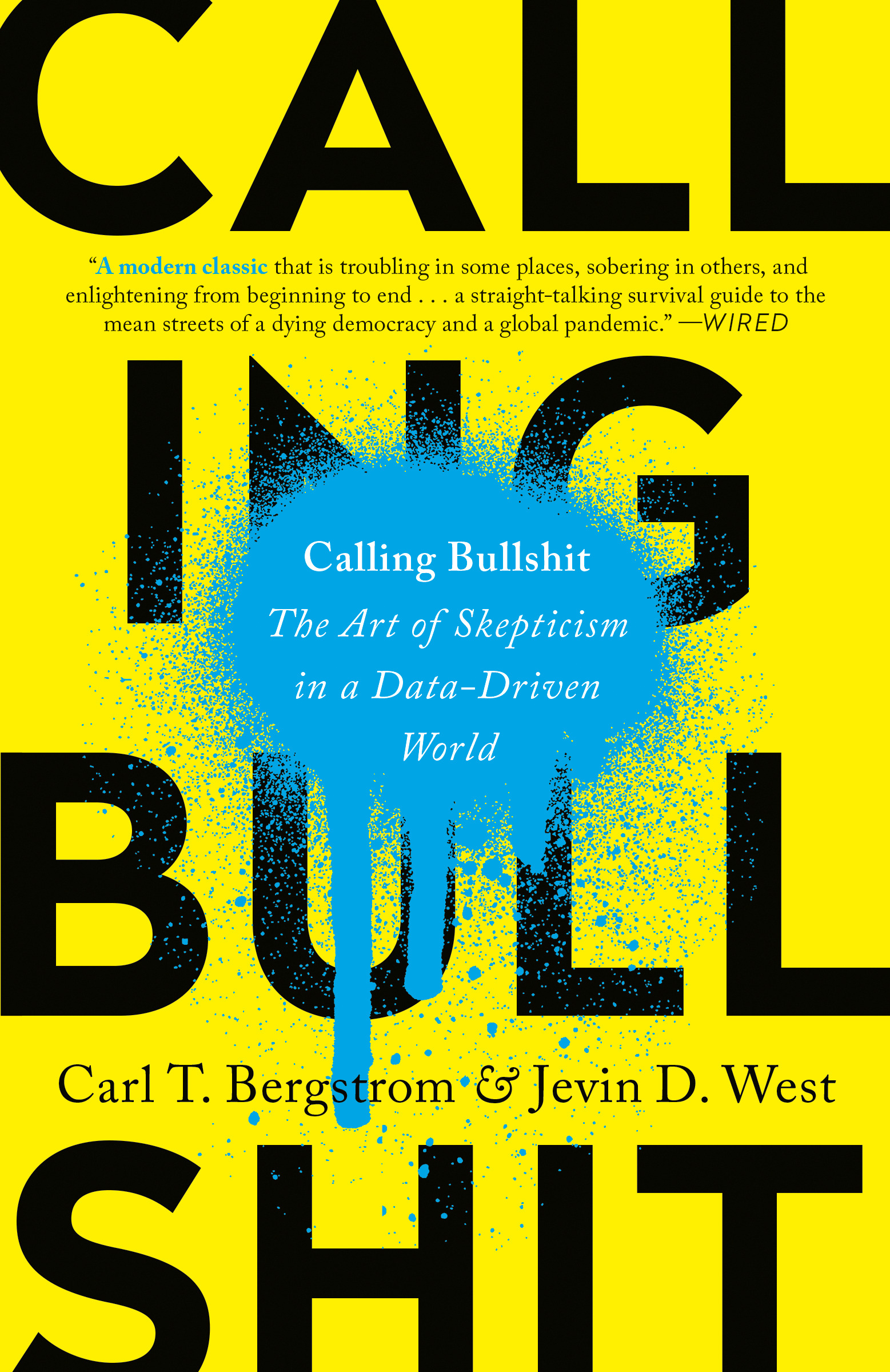
Calling Bullshit Bullshit isn’t what it used to be. Now, two science professors give us the tools to dismantle misinformation and think clearly in a world of fake news and bad data. Misinformation, disinformation, and fake news abound and it’s increasingly difficult to know what’s true. Our media environment has become hyperpartisan. Science is conducted by press release. Startup culture elevates bullshit to high art. We are fairly well equipped to spot the sort of old-school bullshit that is based in fancy rhetoric and weasel words, but most of us don’t feel qualified to challenge the avalanche of new-school bullshit presented in the language of math, science, or statistics. In Calling Bullshit, Professors Carl Bergstrom and Jevin West give us a set of powerful tools to cut through the most intimidating data. You don’t need a lot of technical expertise to call out problems with data. Are the numbers or results too good or too dramatic to be true? Is the claim comparing like with like? Is it confirming your personal bias? Drawing on a deep well of expertise in statistics and computational biology, Bergstrom and West exuberantly unpack examples of selection bias and muddled data visualization, distinguish between correlation and causation, and examine the susceptibility of science to modern bullshit. We have always needed people who call bullshit when necessary, whether within a circle of friends, a community of scholars, or the citizenry of a nation. Now that bullshit has evolved, we need to relearn the art of skepticism. POLITICAL SCIENCE,Corruption & Misconduct
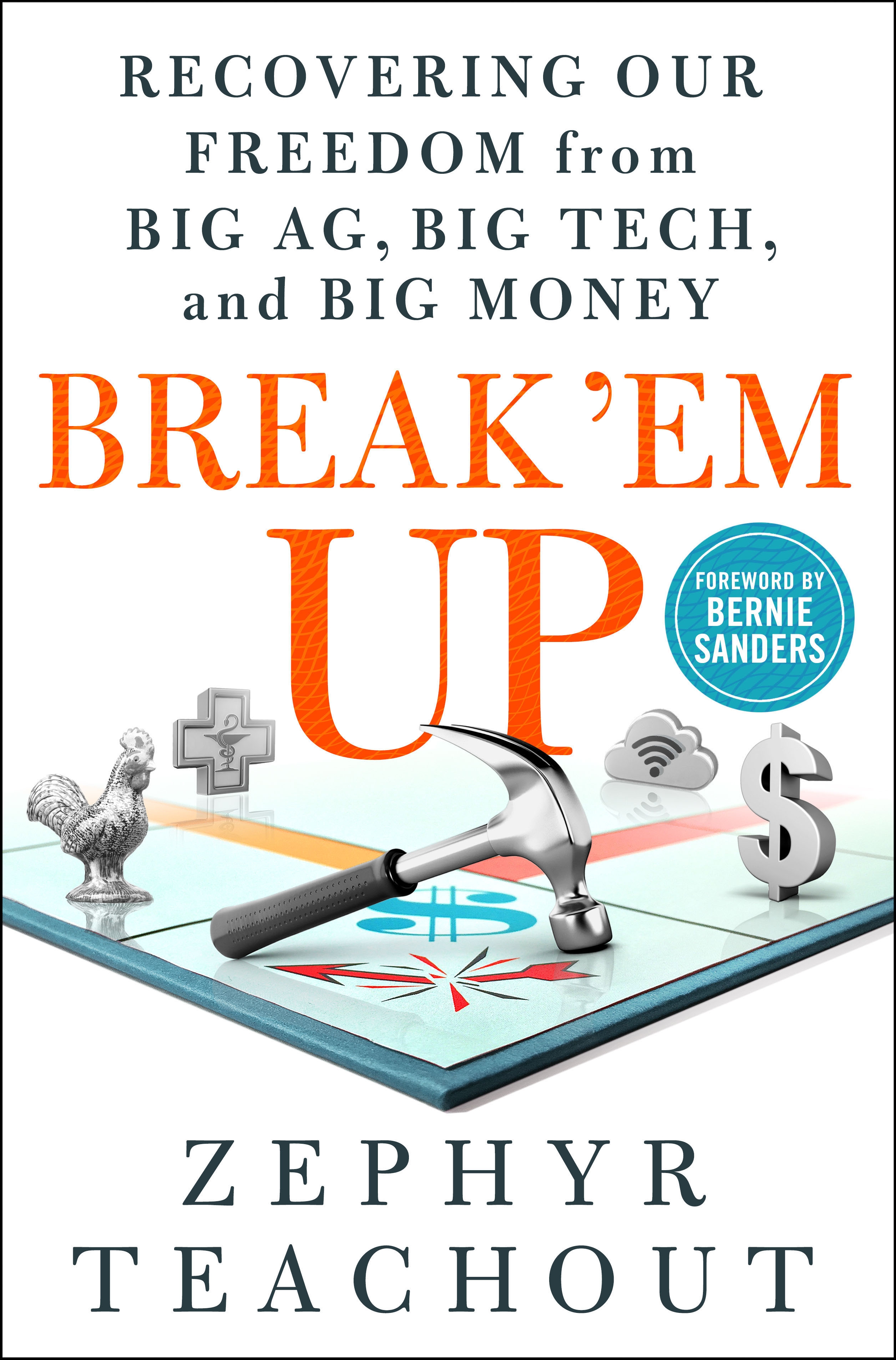
Break 'Em Up "[We need] a grassroots, bottom-up movement that understands the challenge in front of us, and then organizes against monopoly power in communities across this country. This book is a blueprint for that organizing. In these pages, you will learn how monopolies and oligopolies have taken over almost every aspect of American life, and you will also learn about what can be done to stop that trend before it is too late." —From the foreword by Bernie Sanders. A passionate attack on the monopolies that are throttling American democracy. Every facet of American life is being overtaken by big platform monopolists like Facebook, Google, and Bayer (which has merged with the former agricultural giant Monsanto), resulting in a greater concentration of wealth and power than we've seen since the Gilded Age. They are evolving into political entities that often have more influence than the actual government, bending state and federal legislatures to their will and even creating arbitration courts that circumvent the US justice system. How can we recover our freedom from these giants? Anti-corruption scholar and activist Zephyr Teachout has the answer: Break 'Em Up. This book is a clarion call for liberals and leftists looking to find a common cause. Teachout makes a compelling case that monopolies are the root cause of many of the issues that today's progressives care about; they drive economic inequality, harm the planet, limit the political power of average citizens, and historically-disenfranchised groups bear the brunt of their shameful and irresponsible business practices. In order to build a better future, we must eradicate monopolies from the private sector and create new safeguards that prevent new ones from seizing power. Through her expert analysis of monopolies in several sectors and their impact on courts, journalism, inequality, and politics, Teachout offers a concrete path toward thwarting these enemies of working Americans and reclaiming our democracy before it’s too late. POLITICAL SCIENCE,Corruption & Misconduct
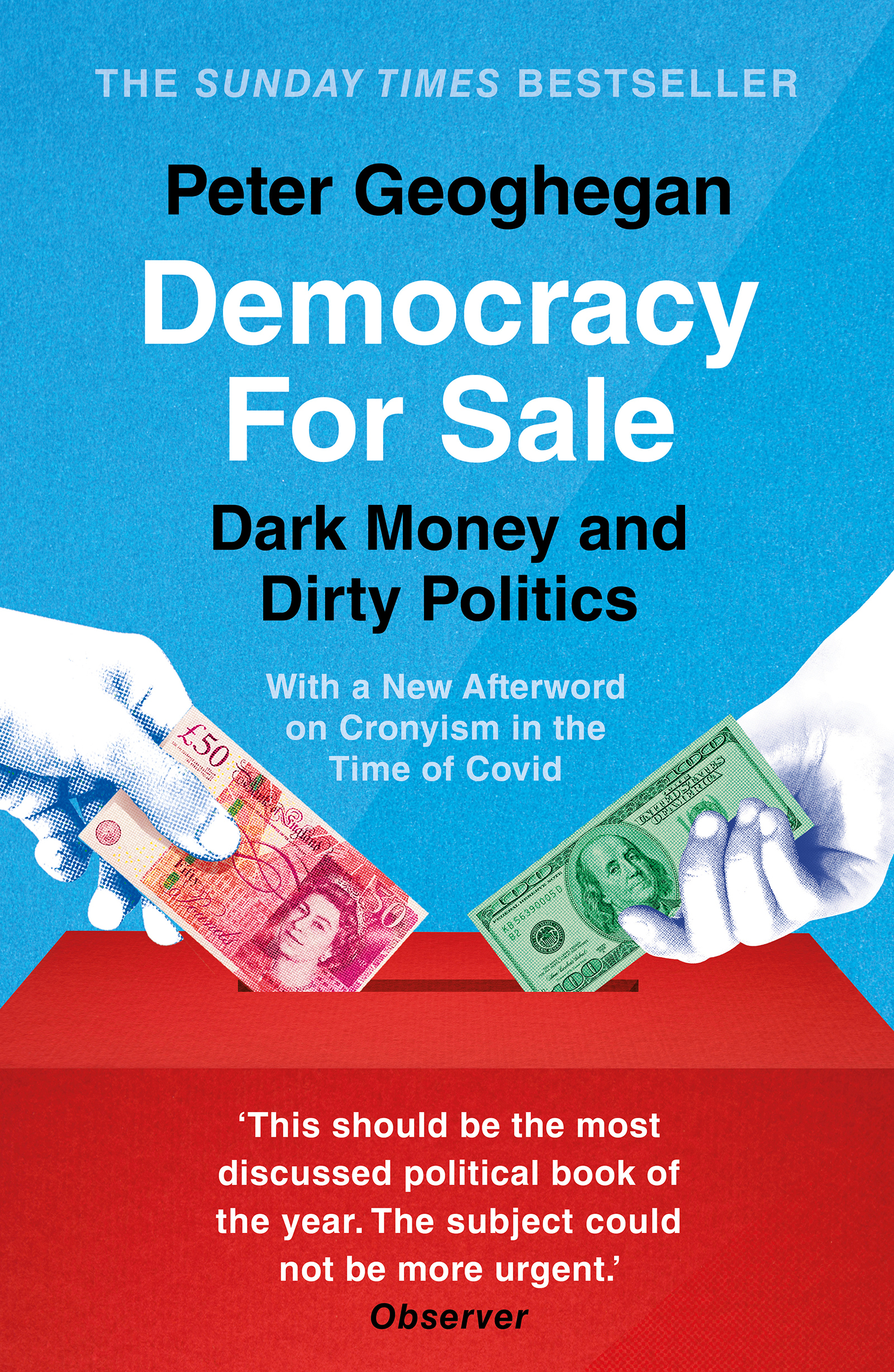
Democracy for Sale The story of how undisclosed donations have infiltrated British politics, undermining public faith in democracy and fuelling the rise of populism across the West. POLITICAL SCIENCE,Corruption & Misconduct

The Grifter's Club An astonishing look inside the gilded gates of Mar-a-Lago, the palatial resort where President Trump conducts government business with little regard for ethics, security, or even the law. Donald Trump's opulent Palm Beach club Mar-a-Lago has thrummed with scandal since the earliest days of his presidency. Long known for its famous and wealthy clientele, the resort's guest list soon started filling with political operatives and power-seekers. Meanwhile, as Trump re-branded Mar-a-Lago "the Winter White House" and began spending weekends there, state business spilled out into full view of the club's members, and vast sums of taxpayer money and political donations began flowing into its coffers, and into the pockets of the president. The Grifter's Club is a breakthrough account of the impropriety, intrigue, and absurdity that has been on display in the place where the president is at his most relaxed. In these pages, a team of prizewinning Miami Herald journalists reveal the activities and motivations of the strange array of charlatans and tycoons who populate its halls. Some peddle influence, some seek inside information, and some just want to soak up the feeling of unfettered access to the world's most powerful leaders. With the drama of an expose and the edgy humor of a Carl Hiaasen novel, The Grifter's Club takes you behind the velvet ropes of this exclusive club and into its bizarre world of extravagance and scandal. POLITICAL SCIENCE,Corruption & Misconduct

Anticorruption President Emeritus of the World Peace Foundation and Fellow of the American Academy of Arts and Sciences, Robert I. Rotberg, showcases how to win the ever-raging anticorruption battle, through this guide for citizens and politicians on either side of the aisle. The phenomenon of corruption has existed since antiquity; from ancient Mesopotamia to our modern-day high-level ethical morass, people have sought a leg up, a shortcut, or an end run to power and influence. In this volume in the MIT Press Essential Knowledge series, Robert Rotberg, a recognized authority on governance and international relations, offers a definitive guide to corruption and anticorruption, charting the evolution of corruption and offering recommendations on how to reduce its power and spread. The most important component of anticorruption efforts, he argues, is leadership that is committed to changing dominant political cultures. POLITICAL SCIENCE,Corruption & Misconduct

Proof of Corruption In the third volume of his Proof series, New York Times bestselling author Seth Abramson takes readers on a deep dive into the Ukraine scandal, revealing it to be more sinister, complex, and transnational than previously thought. Abramson’s research on Trump administration corruption positions the Ukraine scandal as the foreseeable culmination of years of clandestine machinations involving scores of players, from Beijing to Budapest, Ankara to Caracas, Warsaw to Jerusalem, Kyiv to Riyadh, and Moscow to D.C. While many know about the July 2019 telephone call that ignited the Ukraine scandal, most don’t know about the concurrent attempts by members of Trump’s inner circle to take over Ukraine’s national gas company and bolster dangerous pro-Kremlin Ukrainian oligarchs—moves that would have benefited Putin and destabilized Ukraine’s government and economy. In Beijing, Trump’s dealings with the Chinese government not only enriched him and his family, but also culminated in him successfully seeking 2020 election interference from Xi Jinping in the form of closely held information about Joe Biden. In Venezuela, many of the actors involved in the Ukraine scandal engaged in similarly secretive, Kremlin-friendly negotiations that undermined U.S. policy. In Syria and Iraq, Trump’s personal indebtedness to autocrats in Turkey, Israel, Saudi Arabia, and the UAE cost untold lives. And Abramson brings the story back to an increasingly fractured and depleted United States, where the COVID-19 pandemic exposes the staggering domestic consequences of the Trump administration’s foreign machinations. In Proof of Corruption, Seth Abramson lays bare Trump’s decades-long pattern of corruption. This globe-spanning narrative is an urgent warning about the unprecedented threat posed by a corrupt president and his administration. POLITICAL SCIENCE,Corruption & Misconduct
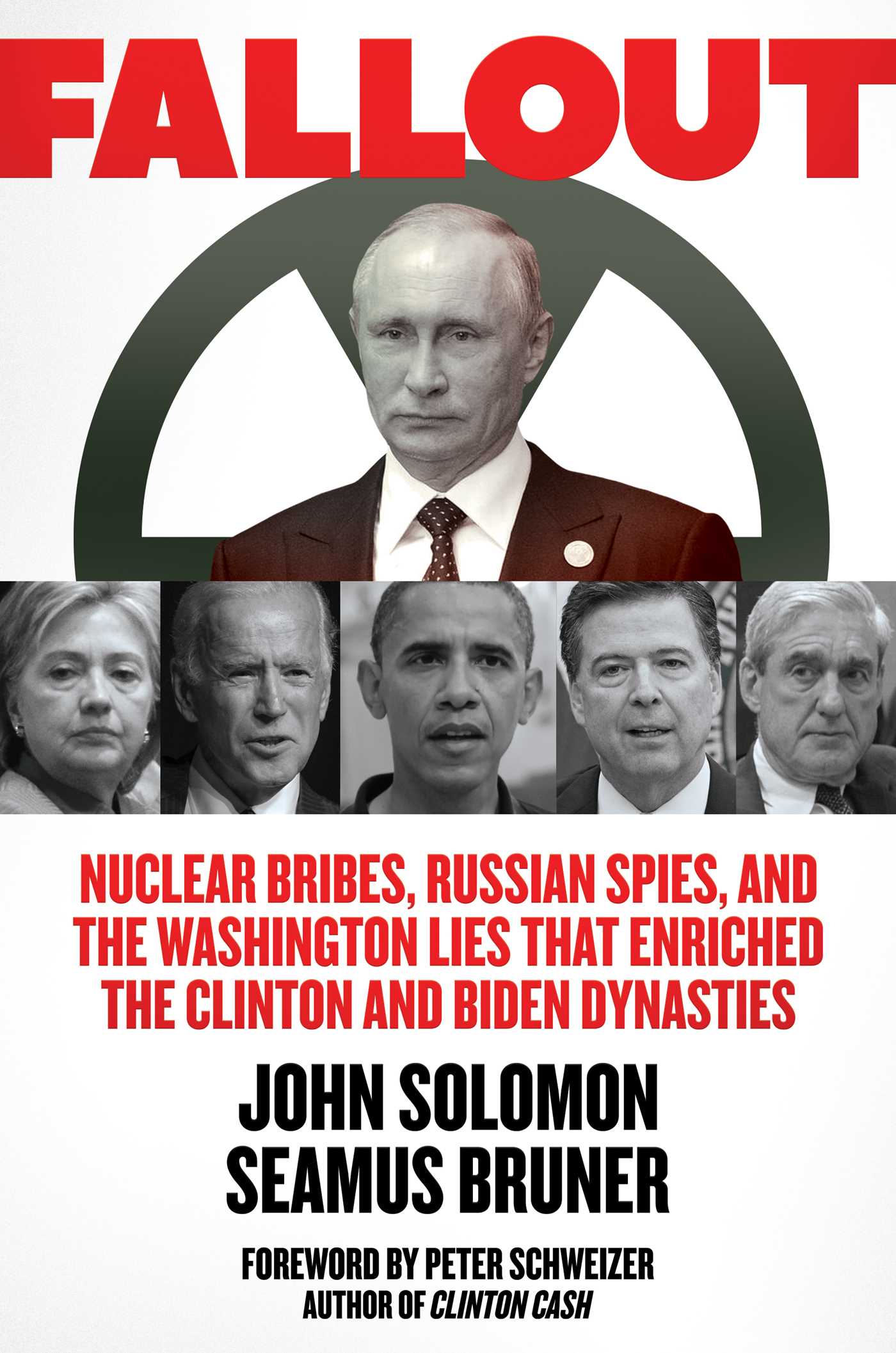
Fallout "This book is a MUST BUY!" – President Donald J. Trump "The Russia and Ukraine scandals are unraveled, corruption and greed exposed. No one is better at uncovering the truth than these two investigative journalists." – Gregg Jarrett, FOX News legal analyst and author of the #1 NYT bestsellers The Russia Hoax and Witch Hunt An exhaustively researched book that reads like an investigative thriller, Fallout reveals how Obama’s “Russian Reset†led to corruption, scandal, and a desperate bid to impeach Donald Trump. In 2015, a major story broke exposing Hillary Clinton’s role in approving the sale of American uranium assets to the Russian state nuclear agency, Rosatom. Not only did the sale of Uranium One put 20 percent of America’s domestic uranium supply under the control of Vladimir Putin, there was also evidence that the Clintons themselves had hugely profited from the deal. When presidential candidate Donald Trump made Uranium One the centerpiece of his “Crooked Hillary†attacks, the Clinton team feared its potential to damage Hillary’s campaign. Others in the Obama-Biden camp worried that if elected, Trump would expose their role in selling out America’s security to Putin. Their desperate need to neutralize the issue led them to launch an unprecedented investigation into the Trump campaign’s purported ties to Russia. The infamous Steele dossier, produced by Clinton-connected Fusion GPS, sparked an investigation under FBI Director James Comey. Instead of ending after the election, the investigation grew bigger, eventually leading to Comey’s firing and the appointment of Special Counsel Robert Mueller. When Mueller failed to find grounds for impeachment, Democrats seized on an ambiguous phone call with the Ukrainian president as a pretext to remove Trump from office. This gambit blew up in their faces when it exposed the secrets that Democrats tried hard to keep buried. An indispensable guide to the hidden background of recent events, Fallout shows how Putin’s bid for nuclear dominance produced a series of political scandals that ultimately posed one of the greatest threats to our democracy in modern American history. POLITICAL SCIENCE,Corruption & Misconduct
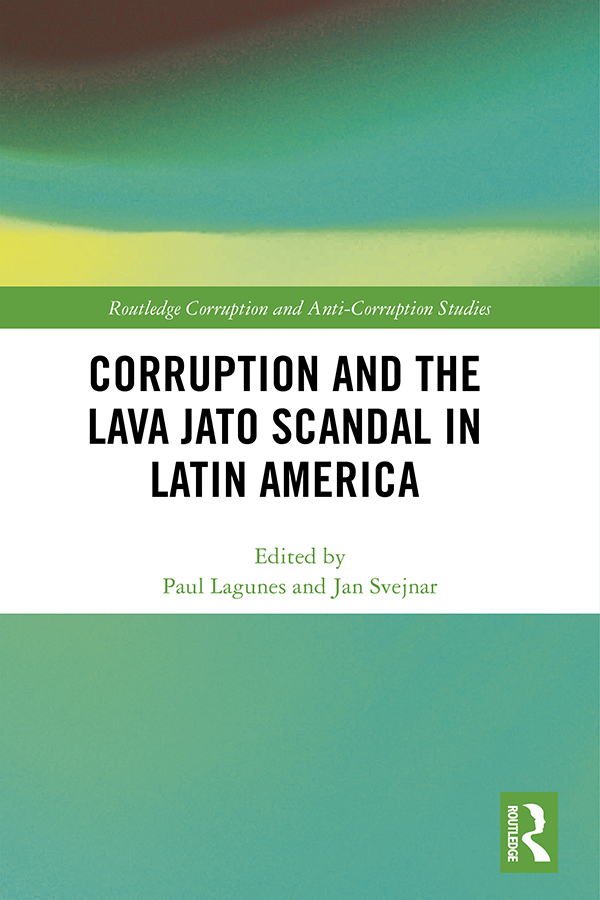
Corruption and the Lava Jato Scandal in Latin America Corruption and the Lava Jato Scandal in Latin America brings together key international and interdisciplinary perspectives to shine new light on Lava Jato, or Operation Car Wash, Latin America’s largest corruption scandal to date. Since 2014, this scandal has unfolded in surprising ways to expose collusion between construction companies and state officials in Brazil and 11 other countries. The corruption uncovered amounts in the order of hundreds of millions of dollars in bribes and billions of dollars in stolen state funds. The volume features evidence that the main construction company at the center of the scandal was—apparently—deliberate about seeking business in corrupt markets. It also evaluates the ambiguous role played by the media, whose members often relied uncritically on classified information released by the authorities. The volume further contributes to our understanding with studies on a number of other relevant topics, including: the overlap between corruption and the planning of the Rio Olympics; Mexico and Peru’s contrasting responses to Lava Jato; the policy reforms needed to avoid a similar scandal in the future; and the roadmap for how Lava Jato should end. Across 15 chapters by leading and emerging scholars and practitioners, this book engages with these issues from a balanced and unbiased perspective, including interviews with key stakeholders on both sides of the case. As one of the first book-length studies to deal with Lava Jato in the English language, this ground-breaking volume is a compelling reading for advanced students and researchers in areas including Corruption Studies, Public Ethics, Political Science, and Latin American Studies, as well as for practitioners working to make governments more accountable. POLITICAL SCIENCE,Corruption & Misconduct
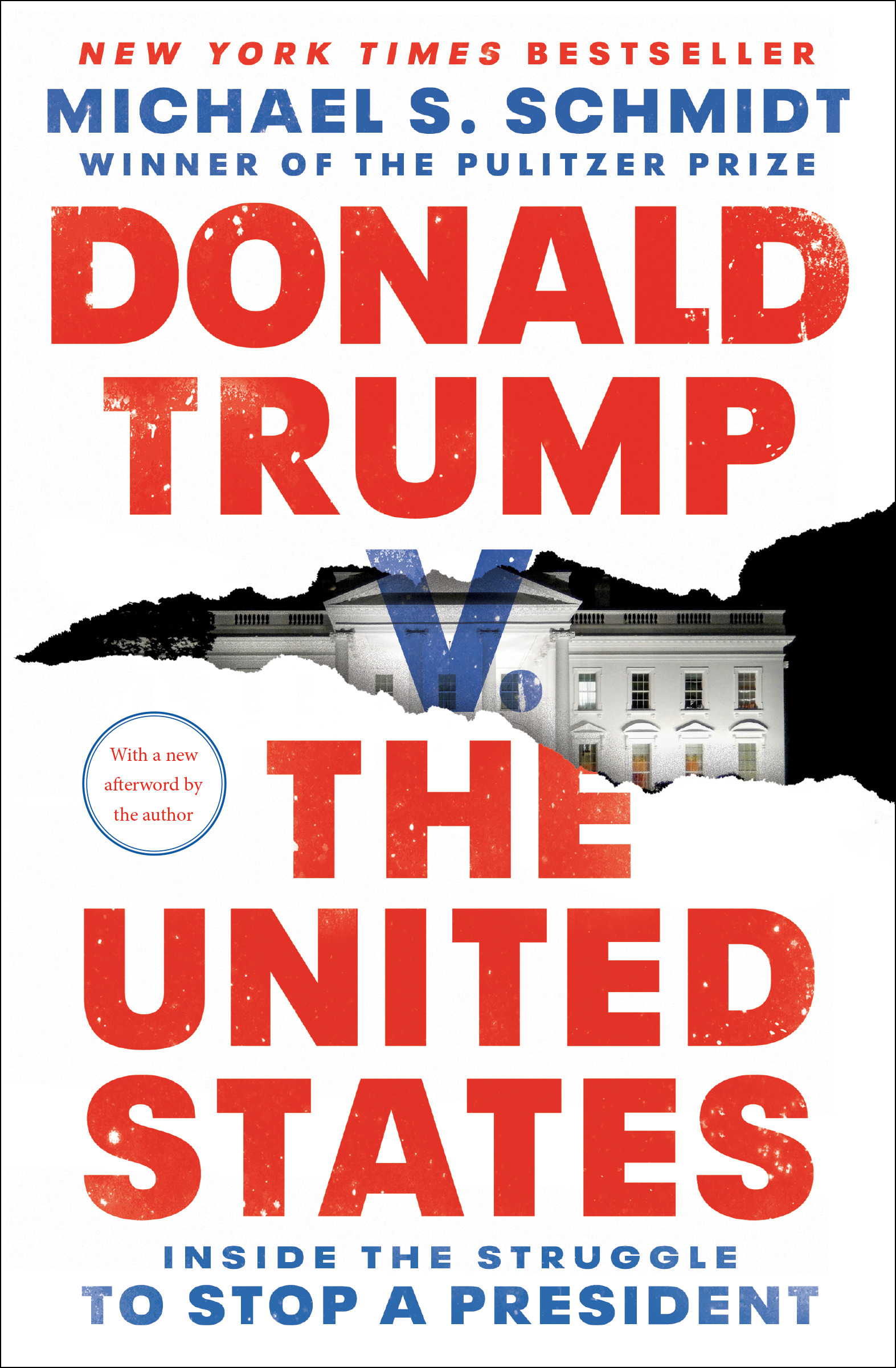
Donald Trump v. The United States NEW YORK TIMES BESTSELLER • With unparalleled reporting, a Pulitzer Prize–winning New York Times reporter continues to break news about the most important political story of our lives as he chronicles the clash between a president and the officials of his own government who tried to stop him. In the early days of the Trump presidency, the people who work in the institutions that make America America saw Trump up close in the Oval Office and became convinced that they had to stand up to an unbound president. These officials faced a situation without parallel in American history: What do you do, and who do you call, if you are the only one standing between the president, his extraordinary powers, and the abyss? Michael S. Schmidt’s Donald Trump v. The United States tells the dramatic, high-stakes story of those who felt compelled to confront and try to contain the most powerful man in the world as he shredded norms and sought to expand his power. Schmidt has broken many of the major stories of the Trump era, from the news of Hillary Clinton’s use of a personal email account to the report on former FBI director James Comey’s contemporaneous memos of conversations with Trump that led directly to the appointment of special counsel Robert S. Mueller III. Now he takes us inside the defining events of the presidency, chronicles them up close, and records the clash between an increasingly emboldened president and those around him, who find themselves trying to thwart the president they had pledged to serve, unsure whether he is acting in the interest of the country, his ego, his family business, or Russia. Through their eyes and ears, we observe an epic struggle. Drawing on secret FBI and White House documents and confidential sources inside federal law enforcement and the West Wing, Donald Trump v. The United States is vital journalism, recording the shocking reality of a presidency like no other, a riveting contemporary history, and a lasting account of just how fragile and vulnerable the institutions of American democracy really are. POLITICAL SCIENCE,Corruption & Misconduct

63 Documents the Government Doesn't Want You to Read The official spin on numerous government programs is flat-out bullshit, according to Jesse Ventura. In this incredible collection of actual government documents, Ventura, the ultimate non- partisan truth-seeker, proves it beyond any doubt. He and Dick Russell walk readers through 63 of the most incriminating programs to reveal what really happens behind the closed doors. In addition to providing original government data, Ventura discusses what it really means and how regular Americans can stop criminal behavior at the top levels of government and in the media. Among the cases discussed: The CIA’s top-secret program to control human behavior Operation Northwoodsthe military plan to hijack airplanes and blame it on Cuban terrorists The discovery of a secret Afghan archiveinformation that never left the boardroom Potentially deadly healthcare cover-ups, including a dengue fever outbreak What the Department of Defense knows about our food supplybut is keeping mum Although these documents are now in the public domain, the powers that be would just as soon they stay under wraps. Ventura’s research and commentary sheds new light on what they’re not telling youand why it matters. POLITICAL SCIENCE,Corruption & Misconduct

Corporate Ties That Bind In the 21st century, corporations have worked their way into government and, as they become increasingly more powerful, arguments about their involvement with public health have become increasingly black and white. With corporations at the center of public health and environmental issues, everything chemical or technological is good, everything natural is bad; scientists who are funded by corporations are right and those who are independent are invariably wrong. There is diminishing common ground between the two opposed sides in these arguments. Corporate Ties that Bind is a collection of essays written by influential academic scholars, activists, and epidemiologists from around the world that scrutinize the corporate reasoning, false science and trickery involving those, like in-house epidemiologists, who mediate the scientific message of organizations who attack and censure independent voices. This book addresses how the growth of corporatism is destroying liberal democracy and personal choice. Whether addressing asbestos, radiation, PCBs, or vaccine regulation, the essays here address the dangers of trusting corporations and uncover the lengths to which corporations put profits before health. POLITICAL SCIENCE,Corruption & Misconduct

I'm from the Government and I'm Here to Kill You Gallup recently found that 49 percent of Americans believe that the government poses “an immediate threat to the rights and freedoms of ordinary citizens.†I’m from the Government and I’m Here to Kill You, written by a former federal attorney, shows that even the 49 percent have no idea how bad things really are. Rights and freedoms are not the only things at stake; all too often government imperils the very lives of those it supposedly serves. Federal employees have, with legal impunity, blown up a town and killed six hundred people, released staggering amounts of radioactive contamination and lied about the resulting cancer, allowed people to die of an easily treated disease in order to study their deaths, and run guns to Mexican drug cartels in hopes of expanding agency powers. Law enforcement leaders have ordered their subordinates to commit murder. Medical administrators have “cooked the books†and allowed patients to die, while raking in plump bonuses. Federal prosecutors have sent Americans to prison while concealing evidence that proved their innocence. I’m from the Government documents how we came to this pass: American courts misconstrued and expanded the old legal concept of sovereign immunity, “the king can do no wrong.†When Congress attempted to allow suits against the government, the legislators used vague language that the courts construed to block most lawsuits. The result is a legal system that allows official negligence to escape legal consequences and paradoxically punishes an agency if it tries to secure public safety. I’m from the Government ends with proposals for legal reforms that will hold the government and its servants accountable when they inflict harm on Americans. POLITICAL SCIENCE,Corruption & Misconduct

Corporate Conspiracies From New York Times bestselling authors Richard Belzer and David Wayne comes a hard look at the wrongs done to us all by big business in America. Here is an explosive account of wrongful acts perpetrated, and the ensuing cover-ups inflicted upon us, by American corporations. The bestselling author team of Richard Belzer and David Wayne exposes the ways that the capitalist regime has got us under their thumbs—from the mainstream media and its control over us, to the trillions stolen by big banks and mortgage companies during the mortgage crisis, to the scams perpetrated by Big Oil and Big Pharma. The one common victim of all that corruption is the American public, and Corporate Conspiracies wants to do something about it. Corporate Conspiracies takes dead aim at those who take advantage of us little guys. Probably most disturbing is the book's examination of politics and capitalism teaming up against us—how politicians and lobbyists all have their hands in each other's pockets while stabbing us in the back, and how the well-established energy lobby—which is petroleum, natural gas, and coal—has played a dominant role in the shaping of US foreign policy for decades. Did you know that companies at times know that their products will kill people, but they do nothing, because it is actually cheaper to compensate the victims than it is to correct the problem? And did you know that the Pentagon is sending $1.5 trillion of our tax dollars to their corporate buddies for a new fighter jet that is already superfluous? This book is guaranteed to make us all think twice about being enslaved and cheated by corporate America. Skyhorse Publishing, as well as our Arcade imprint, are proud to publish a broad range of books for readers interested in history--books about World War II, the Third Reich, Hitler and his henchmen, the JFK assassination, conspiracies, the American Civil War, the American Revolution, gladiators, Vikings, ancient Rome, medieval times, the old West, and much more. While not every title we publish becomes a New York Times bestseller or a national bestseller, we are committed to books on subjects that are sometimes overlooked and to authors whose work might not otherwise find a home. POLITICAL SCIENCE,Corruption & Misconduct

American Nuremberg No subject is more hotly debated than the extreme measures that our government has taken after 9/11 in the name of national security. Torture, extraordinary rendition, drone assassinations, secret detention centers (or black sitesâ€), massive surveillance of citizens. But while the press occasionally exposes the dark side of the war on terror and congressional investigators sometimes raise alarms about the abuses committed by U.S. intelligence agencies and armed forces, no high U.S. official has been prosecuted for these violations which many legal observers around the world consider war crimes. The United States helped establish the international principles guiding the prosecution of war crimes starting with the Nuremberg tribunal following World War II, when Nazi officials were held accountable for their crimes against humanity. But the American government and legal system have consistently refused to apply these same principles to our own officials. Now Rebecca Gordon takes on the explosive task of indicting†the officials who in a just society should be put on trial for war crimes. Some might dismiss this as a symbolic exercise. But what is at stake here is the very soul of the nation. POLITICAL SCIENCE,Corruption & Misconduct

Bravehearts Whistleblowers pay with their lives to save ours. When insiders like former NSA analyst Edward Snowden or ex-FBI agent Coleen Rowley or Big Tobacco truth-teller Jeffrey Wigand blow the whistle on high-level lying, lawbreaking or other wrongdoingwhether it's government spying, corporate murder or scientific scandalthe public benefits enormously. Wars are ended, deadly products are taken off the market, white-collar criminals are sent to jail. The whistleblowers themselves, however, generally end up ruined. Nearly all of them lose their jobsand in many cases their marriages and their healthas they refuse to back down in the face of increasingly ferocious official retaliation. That moral stubbornness despite terrible personal cost is the defining DNA of whistleblowers. The public owes them more than we know. In Bravehearts, Hertsgaard tells the gripping, sometimes darkly comic and ultimately inspiring stories of the unsung heroes of our time. A deeply reported, impassioned polemic, Bravehearts is a book for citizens everywhereespecially students, teachers, activists and anyone who wants to make a difference in the world around them. POLITICAL SCIENCE,Corruption & Misconduct

Follow the Money As seen on The Ben Shapiro Show! Follow the Money exposes the labyrinth of connections between D.C.’s slimiest swamp creatures—Democrat operatives, lying informants, desperate and destructive FBI agents, Obama power brokers, CIA renegade John Brennan, George Soros, and more—who conspired to attack Trump by manufacturing one bogus scandal after another. Bestselling author, podcast favorite, and Fox News contributor Dan Bongino delivers the third and most shocking of his acclaimed series chronicling the Deep State war against Donald Trump. Starting with the Trump impeachment hearings, Bongino works forward and backward to piece together the connections of a vast, well-funded cabal of wealthy Democrats and D.C. swamp elite to the non-stop deluge of manufactured scandals launched specifically to attack, destabilize, and ultimately remove Trump and his administration. Zooming in on Ukraine, Bongino unspools a complex sequence of corruption—from the miraculous “discovery†of a mysterious black ledger that linked financial transactions to Trump campaign insider Paul Manafort and cast a shadow over the entire Trump team, to Joe Biden’s unexamined quid pro quo interference with Kyiv politics as he threatened to withhold a loan unless a prosecutor was removed from office. The former Secret Service agent exposes how Glenn Simpson, the corrupt cheerleader behind the lie-filled Steele dossier, wrangled millions from top Democrat donor George Soros to meddle in Ukraine politics. Bongino also reveals Soros’s desperate multimillion-dollar plan to stop Trump’s re-election. Using FBI documents, Bongino reveals the outrageous actions of Robert Mueller’s investigators, who sat on evidence that proved the supposedly damning Trump Tower meeting between a Russian lawyer and senior campaign officials was nothing more than a twenty-minute waste of time for all involved. Other chapters delve into the disturbing presence of Obama’s fixer, obstruction angel Kathryn “Kathy†Ruemmler, who represents a rogues gallery of Russiagate political operatives; the FBI’s inside source on the National Security Council, Anthony Ferrante, who dedicated himself to the fruitless task of trying to prove the Steele dossier was legitimate; and “Special Agent 1†Stephen M. Somma’s curious obsession with Lt. Gen. Michael Flynn, which was stoked by a Flynn-fixated paid operative named Stefan Halper. Flynn is the centerpiece of one of the book’s most revealing chapters, in which Bongino deconstructs the FBI’s elaborate takedown of Trump’s National Security Advisor, revealing how and why the three-star general was set up not once…but three times. Bongino also returns to the last, desperate attempt to derail Trump—the impeachment trial—and uncovers Adam Schiff’s lies and the Ukraine-call whistleblower’s multiple secret ties to never-Trumpers and Schiff himself. In the final chapter, Bongino unveils the newest front to stop Trump: the unleashing of COVID-19 from China and how the disease mutated from a killer plague in Wuhan to a weapon to destroy America’s economy and, with it, Trump’s re-election chances. Follow the Money displays dizzying detective work from a truly relentless, passionate, and patriotic reporter. An astonishing chronicle of the relentless war to destroy Donald Trump and his administration, this exposé is a must-read for anyone who wants to unravel the most shocking and corrupt campaign to unseat a sitting president in American history. POLITICAL SCIENCE,Corruption & Misconduct
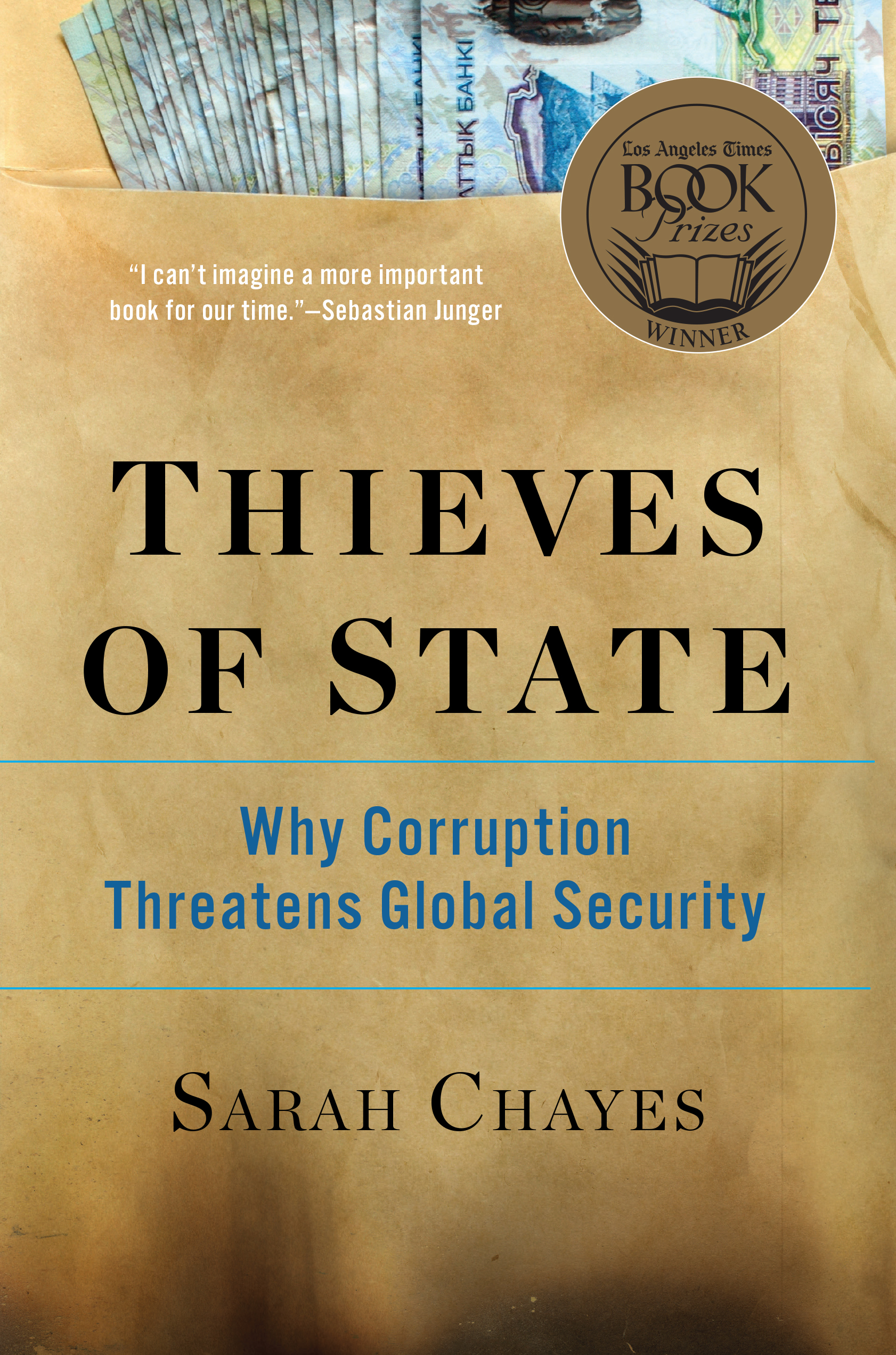
Thieves of State Winner of the 2015 Los Angeles Times Book Prize for Current Interest. "I can’t imagine a more important book for our time." —Sebastian Junger The world is blowing up. Every day a new blaze seems to ignite: the bloody implosion of Iraq and Syria; the East-West standoff in Ukraine; abducted schoolgirls in Nigeria. Is there some thread tying these frightening international security crises together? In a riveting account that weaves history with fast-moving reportage and insider accounts from the Afghanistan war, Sarah Chayes identifies the unexpected link: corruption. Since the late 1990s, corruption has reached such an extent that some governments resemble glorified criminal gangs, bent solely on their own enrichment. These kleptocrats drive indignant populations to extremes—ranging from revolution to militant puritanical religion. Chayes plunges readers into some of the most venal environments on earth and examines what emerges: Afghans returning to the Taliban, Egyptians overthrowing the Mubarak government (but also redesigning Al-Qaeda), and Nigerians embracing both radical evangelical Christianity and the Islamist terror group Boko Haram. In many such places, rigid moral codes are put forth as an antidote to the collapse of public integrity. The pattern, moreover, pervades history. Through deep archival research, Chayes reveals that canonical political thinkers such as John Locke and Machiavelli, as well as the great medieval Islamic statesman Nizam al-Mulk, all named corruption as a threat to the realm. In a thrilling argument connecting the Protestant Reformation to the Arab Spring, Thieves of State presents a powerful new way to understand global extremism. And it makes a compelling case that we must confront corruption, for it is a cause—not a result—of global instability. POLITICAL SCIENCE,Corruption & Misconduct
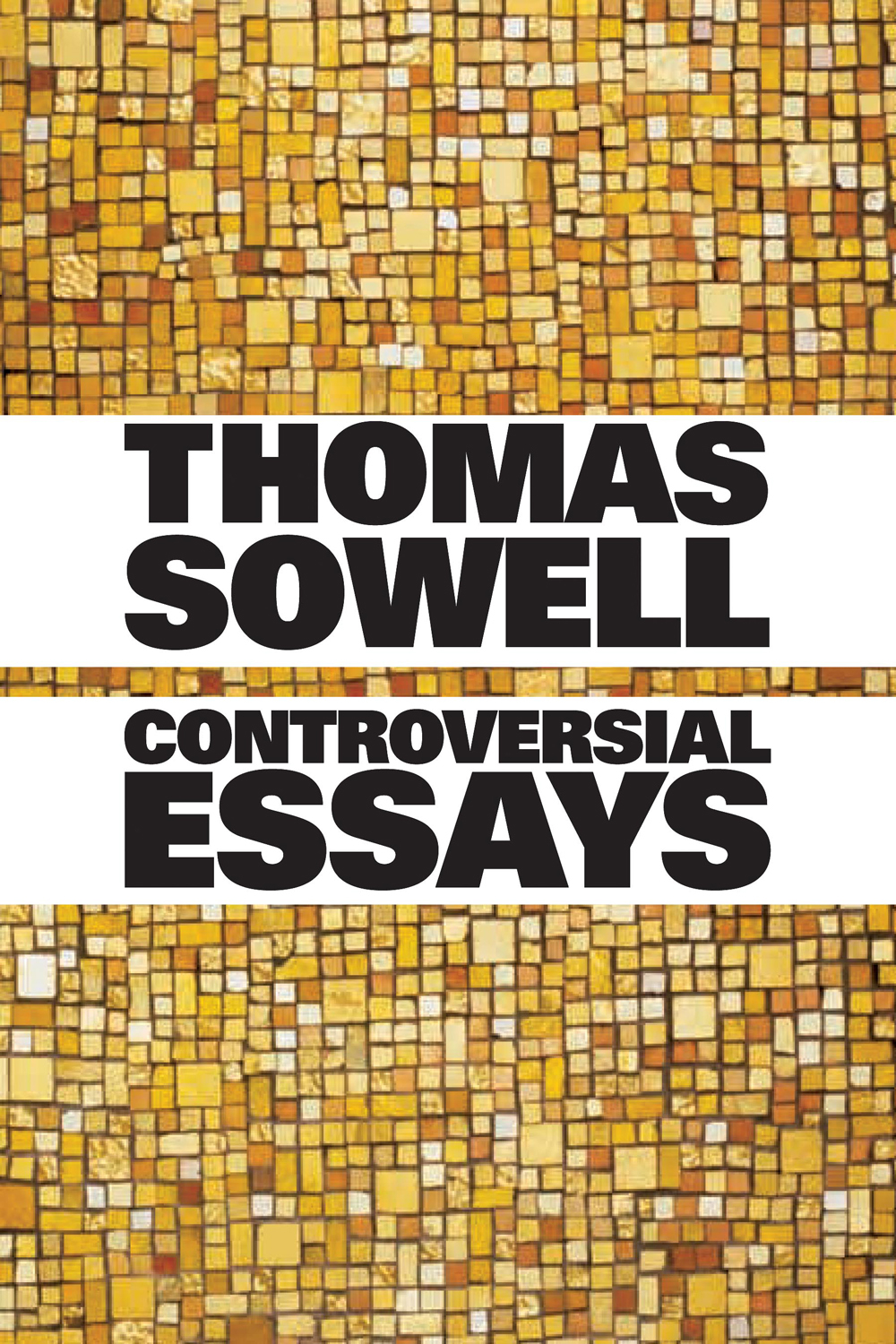
Controversial Essays One of conservatism's most articulate voices dissects today's most important economic, racial, political, education, legal, and social issues, sharing his entertaining and thought-provoking insights on a wide range of contentious subjects. --"This book contains an abundance of wisdom on a large number of economic issues." --Mises Review POLITICAL SCIENCE,Essays
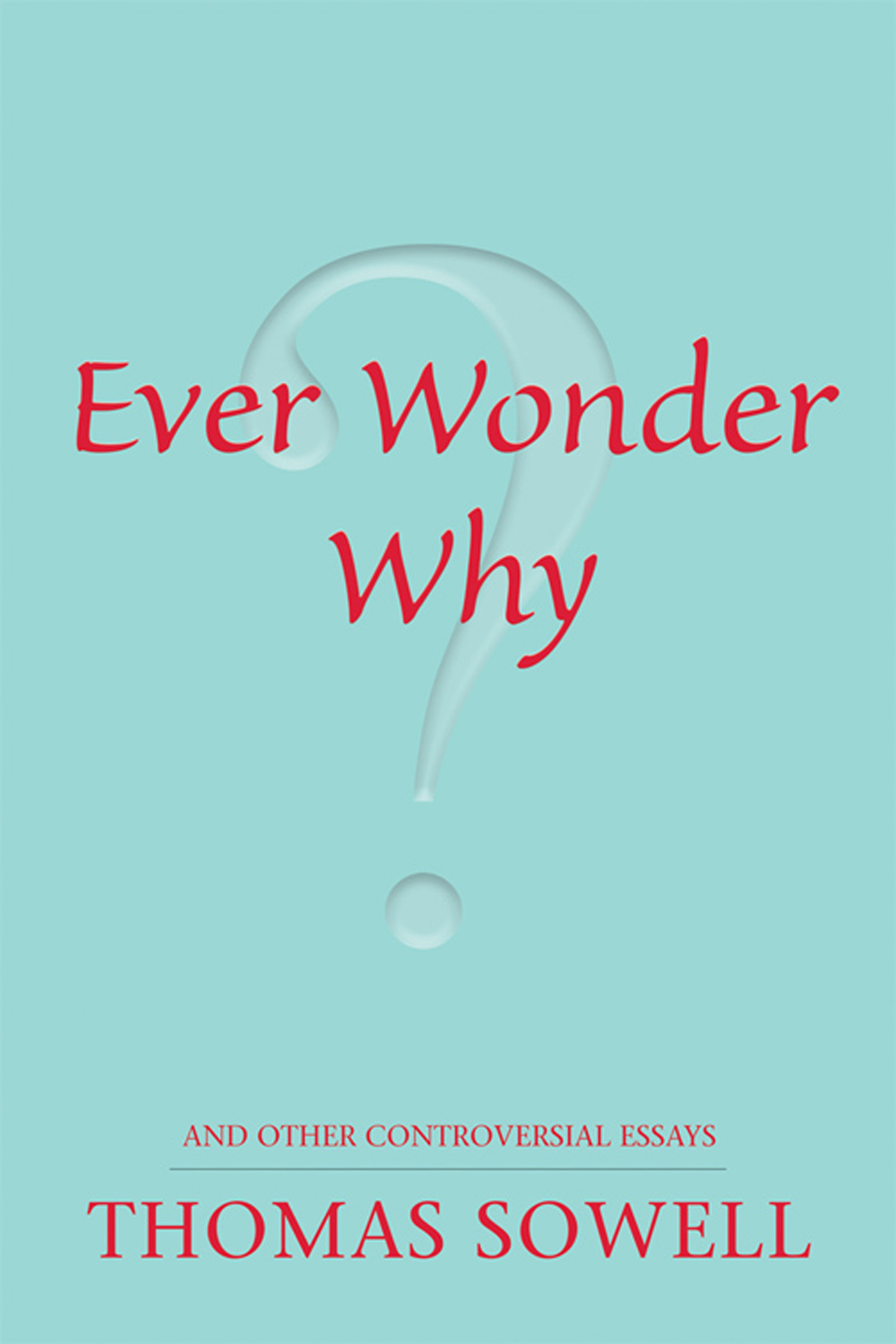
Ever Wonder Why? Thomas Sowell takes aim at a range of legal, social, racial, educational, and economic issues in this latest collection of his controversial, never boring, always thought-provoking essays. From "gun control myths" to "mealy mouth media" to "free lunch medicine," Sowell gets to the heart of the matters we all care about with his characteristically unsparing candor. POLITICAL SCIENCE,Essays
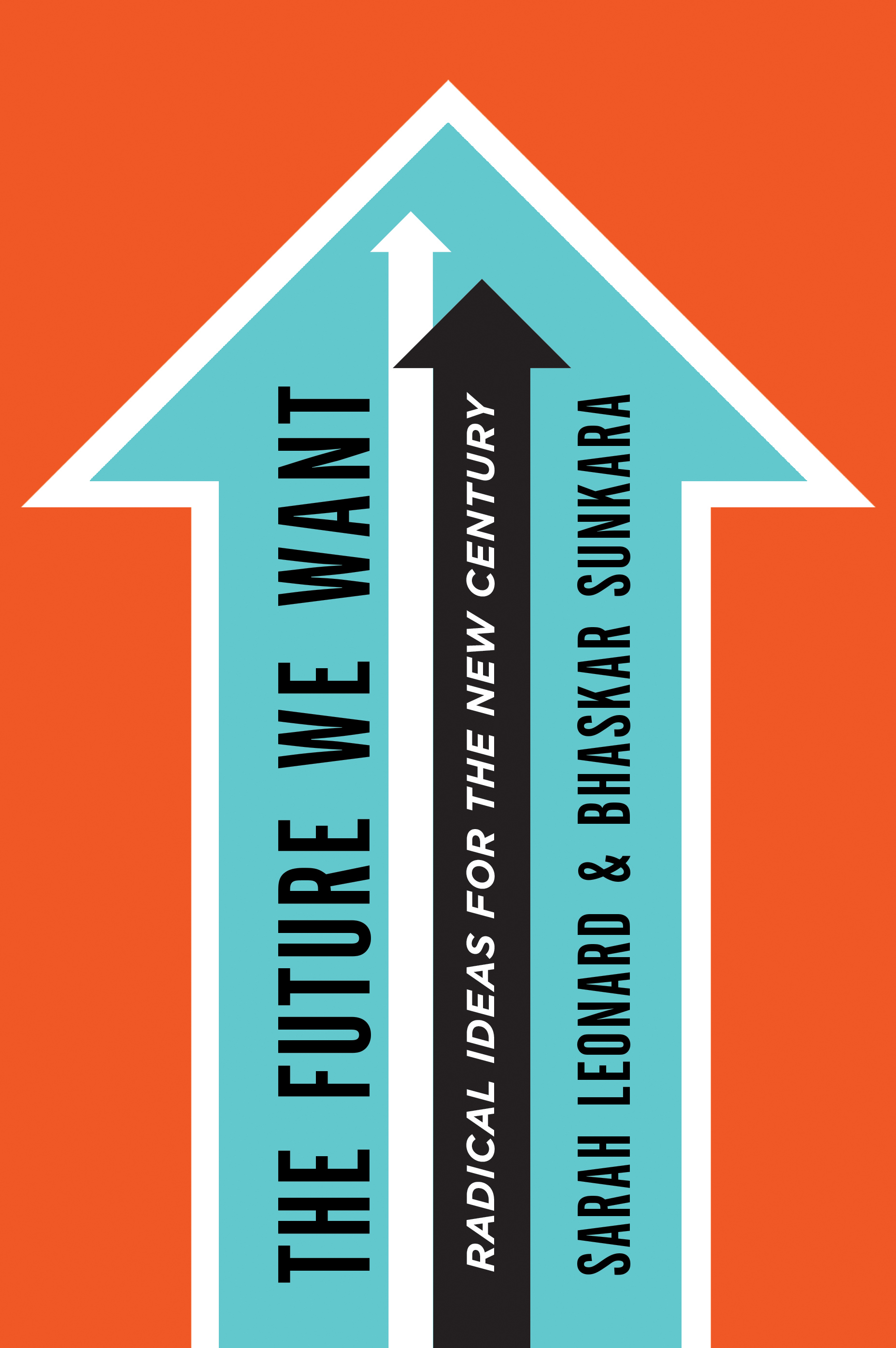
The Future We Want A stirring blueprint for American equality, from the "breakout stars" (The New York Times) of the young new left Democrat, Republican -- the list of presidential candidates confirms that business is proceeding pretty much as usual. The Future We Want proposes something different. In a sharp, rousing collective manifesto, ten young cultural and political critics dismantle the usual liberal solutions to America's ills and propose a pragmatic alternative. What would finance look like without Wall Street? Or the workplace with responsibility shared by the entire workforce? From a campaign to limit work hours, to a program for full employment, to proposals for a new feminism, The Future We Want has the courage to think of alternatives that are both utopian and possible. Brilliantly clear and provocative, The Future We Want -- edited by Jacobin magazine founder Bhaskar Sunkara and the Nation's Sarah Leonard -- harnesses the energy and creativity of an angry generation and announces the arrival of a new political left that not only protests but plans. POLITICAL SCIENCE,Essays
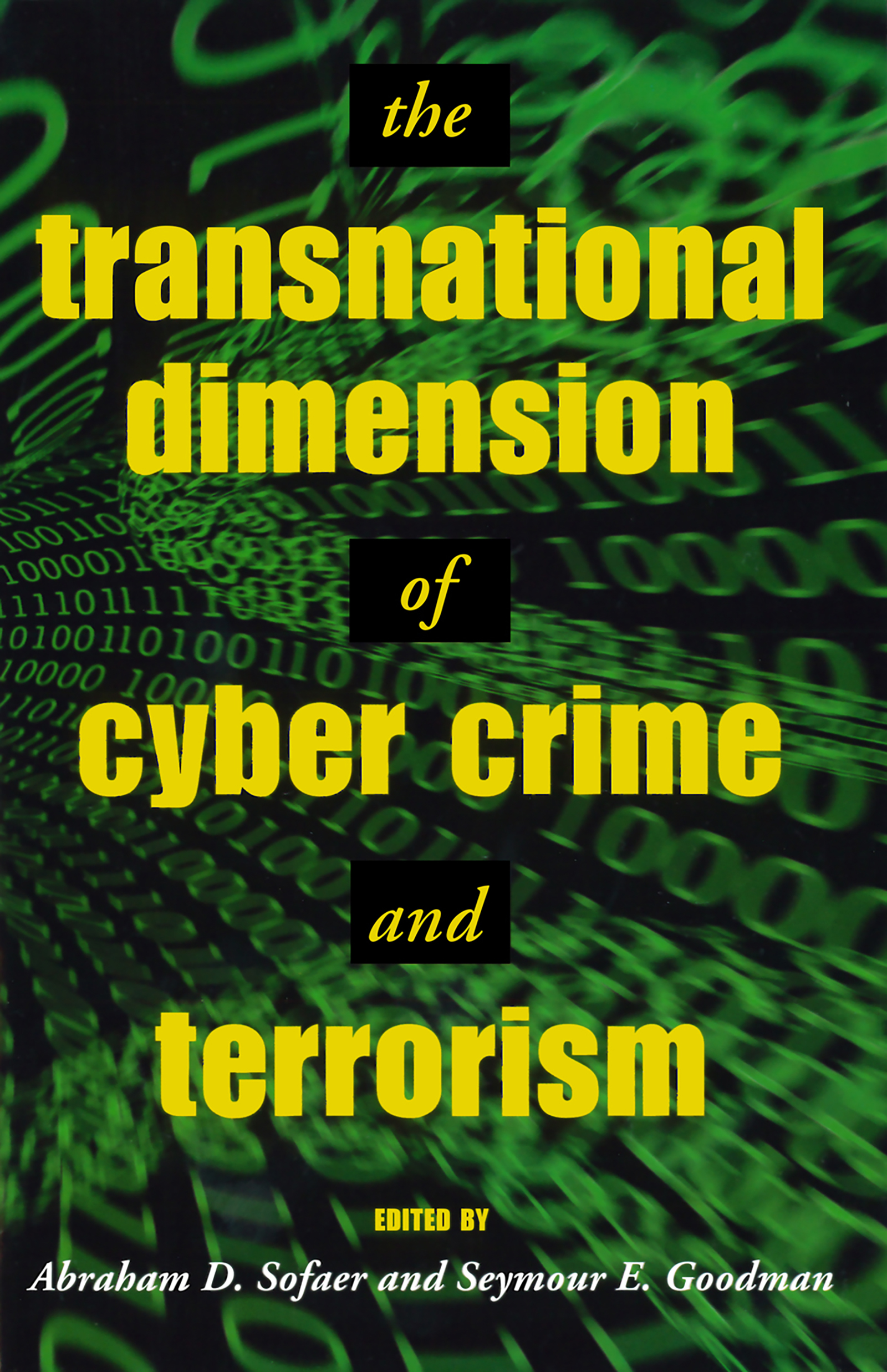
The Transnational Dimension of Cyber Crime and Terrorism In December 1999, more than forty members of government, industry, and academia assembled at the Hoover Institution to discuss this problem and explore possible countermeasures. The Transnational Dimension of Cyber Crime and Terrorism summarizes the conference papers and exchanges, addressing pertinent issues in chapters that include a review of the legal initiatives undertaken around the world to combat cyber crime, an exploration of the threat to civil aviation, analysis of the constitutional, legal, economic, and ethical constraints on use of technology to control cyber crime, a discussion of the ways we can achieve security objectives through international cooperation, and more. Much has been said about the threat posed by worldwide cyber crime, but little has been done to protect against it. A transnational response sufficient to meet this challenge is an immediate and compelling necessity—and this book is a critical first step in that direction. POLITICAL SCIENCE,Essays

This Muslim American Life Read Moustafa's Op-ed on Trump's Executive Order Against Muslims in The Guardian Winner of the 2016 Evelyn Shakir Non-Fiction Arab American Book Award Over the last few years, Moustafa Bayoumi has been an extra in Sex and the City 2 playing a generic Arab, a terrorist suspect (or at least his namesake “Mustafa Bayoumi†was) in a detective novel, the subject of a trumped-up controversy because a book he had written was seen by right-wing media as pushing an “anti-American, pro-Islam†agenda, and was asked by a U.S. citizenship officer to drop his middle name of Mohamed. Others have endured far worse fates. Sweeping arrests following the terrorist attacks of September 11, 2001 led to the incarceration and deportation of thousands of Arabs and Muslims, based almost solely on their national origin and immigration status. The NYPD, with help from the CIA, has aggressively spied on Muslims in the New York area as they go about their ordinary lives, from noting where they get their hair cut to eavesdropping on conversations in cafés. In This Muslim American Life, Moustafa Bayoumi reveals what the War on Terror looks like from the vantage point of Muslim Americans, highlighting the profound effect this surveillance has had on how they live their lives. To be a Muslim American today often means to exist in an absurd space between exotic and dangerous, victim and villain, simply because of the assumptions people carry about you. In gripping essays, Bayoumi exposes how contemporary politics, movies, novels, media experts and more have together produced a culture of fear and suspicion that not only willfully forgets the Muslim-American past, but also threatens all of our civil liberties in the present. POLITICAL SCIENCE,Essays

American Political Rhetoric American Political Rhetoric is the only reader for introductory classes in American politics, government, and political communication designed to explore fundamental political principles through classic examples of political rhetoric. Now in its seventh edition, its selections include the entire political spectrum and contributors range from our nation's founders to contemporary elected public officials, Supreme Court opinions, and representatives of historic movements for social change. POLITICAL SCIENCE,Essays

The View from Flyover Country NEW YORK TIMES and MIBA BESTSELLER From the St. Louis–based journalist often credited with first predicting Donald Trump’s presidential victory. "A collection of sharp-edged, humanistic pieces about the American heartland...Passionate pieces that repeatedly assail the inability of many to empathize and to humanize." — Kirkus In 2015, Sarah Kendzior collected the essays she reported for Al Jazeera and published them as The View from Flyover Country, which became an ebook bestseller and garnered praise from readers around the world. Now, The View from Flyover Country is being released in print with an updated introduction and epilogue that reflect on the ways that the Trump presidency was the certain result of the realities first captured in Kendzior’s essays. A clear-eyed account of the realities of life in America’s overlooked heartland, The View from Flyover Country is a piercing critique of the labor exploitation, race relations, gentrification, media bias, and other aspects of the post-employment economy that gave rise to a president who rules like an autocrat. The View from Flyover Country is necessary reading for anyone who believes that the only way for America to fix its problems is to first discuss them with honesty and compassion. “Please put everything aside and try to get ahold of Sarah Kendzior’s collected essays, The View from Flyover Country. I have rarely come across writing that is as urgent and beautifully expressed. What makes Kendzior’s writing so truly important is [that] it . . . documents where the problem lies, by somebody who lives there.â€â€”The Wire “Sarah Kendzior is as harsh and tenacious a critic of the Trump administration as you’ll find. She isn’t some new kid on the political block or a controversy machine. . . .Rather she is a widely published journalist and anthropologist who has spent much of her life studying authoritarianism.†—Columbia Tribune POLITICAL SCIENCE,Essays
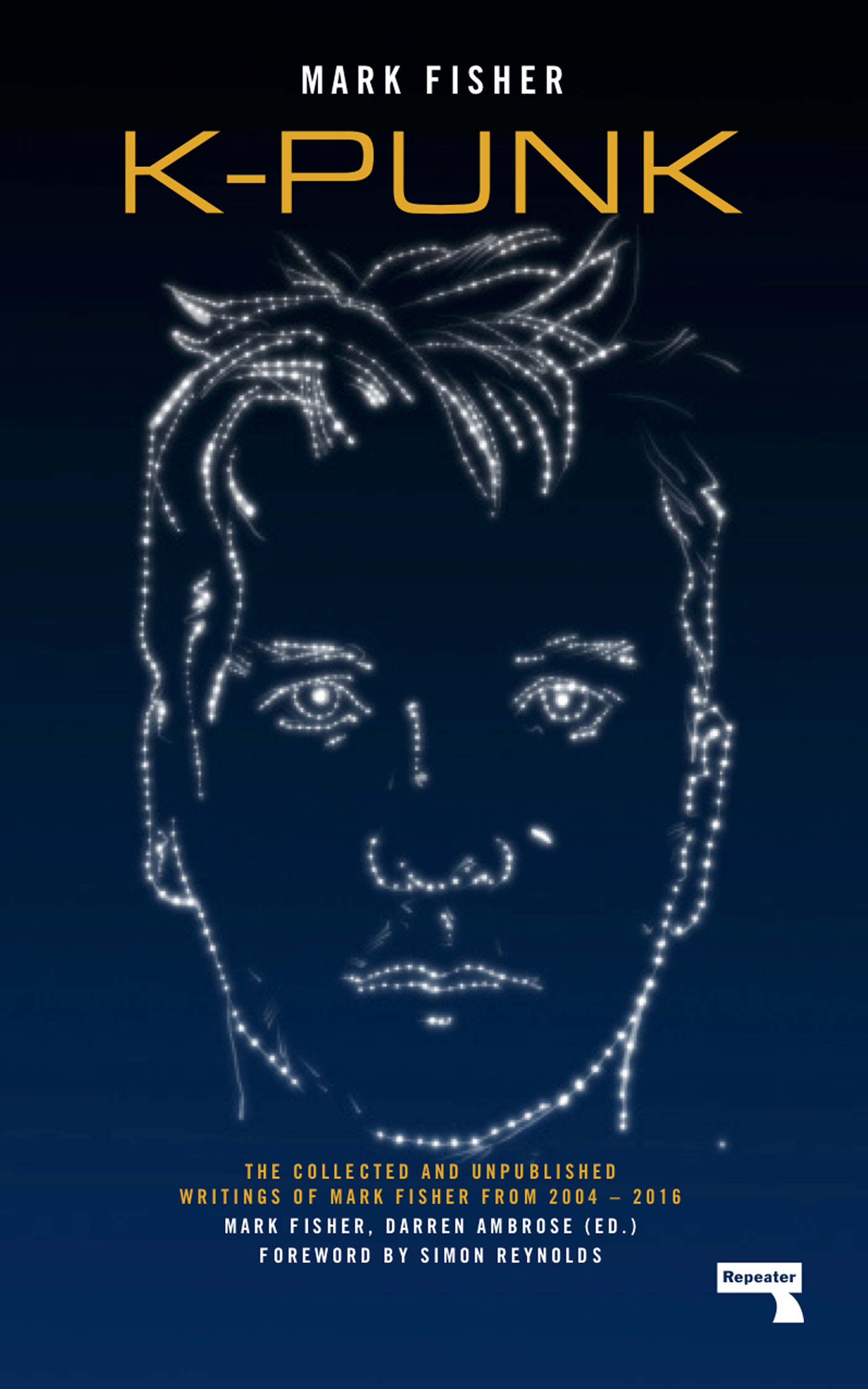
K-punk A comprehensive collection of the writings of Mark Fisher (1968-2017), whose work defined critical writing for a generation. This comprehensive collection brings together the work of acclaimed blogger, writer, political activist and lecturer Mark Fisher (aka k-punk). Covering the period 2004 - 2016, the collection will include some of the best writings from his seminal blog k-punk; a selection of his brilliantly insightful film, television and music reviews; his key writings on politics, activism, precarity, hauntology, mental health and popular modernism for numerous websites and magazines; his final unfinished introduction to his planned work on "Acid Communism"; and a number of important interviews from the last decade. Edited by Darren Ambrose and with a foreword by Simon Reynolds. POLITICAL SCIENCE,Essays

The Point of It All NEW YORK TIMES BESTSELLER • A powerful collection of the influential columnist’s most important works—featuring rare speeches, a major essay about today’s populist movements and the future of global democracy, and a new preface by the author’s son, Daniel Krauthammer “Charles will be remembered as one of the greatest public intellects of his generation.”—John McCain In his decades of work as America’s preeminent political commentator, whether writing about statecraft and foreign policy or reflecting on more esoteric topics such as baseball, spaceflight and medical ethics, Charles Krauthammer elevated the opinion column to a form of art. This collection features the columns, speeches and unpublished writings that showcase the best of his original thought and his last, enduring words on the state of American politics, the nature of liberal democracy and the course of world history. The book also includes a deeply personal section offering insight into Krauthammer’s beliefs about what mattered most to him: friendship, family and the principles he lived by. The Point of It All is a timely demonstration of what made Charles Krauthammer the most celebrated American columnist and political thinker of his generation, a revealing look at the man behind the words and a lasting testament to his belief that anyone with an open and honest mind can grapple deeply with the most urgent questions in politics and in life. POLITICAL SCIENCE,Essays
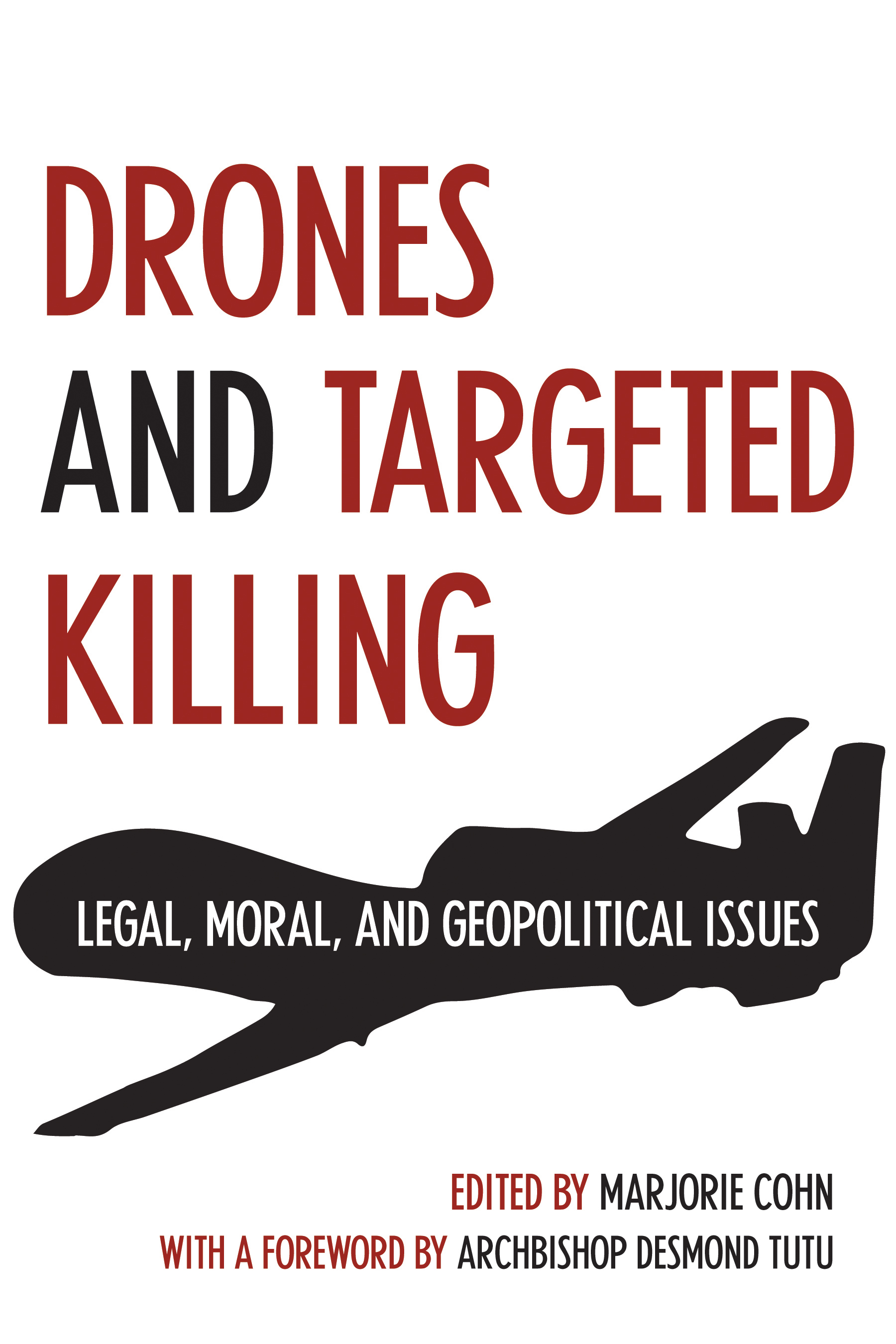
Drones and Targeted Killing EXPERT ANALYSIS OF AN ILLEGAL AND IMMORAL PRACTICE The Bush administration detained and tortured suspected terrorists; the Obama administration assassinates them. Assassination, or targeted killing, off the battlefield not only causes more resentment against the United States, it is also illegal. In this interdisciplinary collection, human rights and political activists, policy analysts, lawyers and legal scholars, a philosopher, a journalist and a sociologist examine different aspects of the U.S. policy of targeted killing with drones and other methods. It explores the legality, morality and geopolitical considerations of targeted killing and resulting civilian casualties, and evaluates the impact on relations between the United States and affected countries. The book includes the documentation of civilian casualties by the leading non-governmental organization in this area; stories of civilians victimized by drones; an analysis of the first U.S. targeted killing lawsuit by the lawyer who brought the case; a discussion of the targeted killing cases in Israel by the director of PCATI which filed one of the lawsuits; the domestic use of drones; and the immorality of drones using Just War principles. Contributors include: Archbishop Desmond Tutu, Phyllis Bennis, Medea Benjamin, Marjorie Cohn, Richard Falk, Tom Hayden, Pardiss Kebriaei, Jane Mayer, Ishai Menuchin, Jeanne Mirer, John Quigley, Dr. Tom Reifer, Alice Ross, Jay Stanley, and Harry Van der Linden. POLITICAL SCIENCE,Essays

Harry's Last Stand 'A kind of epic poem, one that moves in circular fashion from passionate denunciation to intense autobiographical reflection ... should be required reading for every MP, peer, councillor, civil servant and commentator. The fury and sense of powerlessness that so many people feel at government policy beam out of every page.' The Guardian ‘It is not enough to read Harry’s record of the struggles and hopes of a generation – we have to re-assert his principles of common ownership and the welfare state. If Harry can do it, we should too!’ Ken Loach, Director of I, Daniel Blake ‘As one of the last remaining survivors of the Great Depression and the Second World War, I will not go gently into that good night. I want to tell you what the world looks like through my eyes, so that you can help change it…’ In November 2013, 91-year-old Yorkshireman, RAF veteran and ex-carpet salesman Harry Leslie Smith’s Guardian article – ‘This year, I will wear a poppy for the last time’ – was shared over 80,000 times on Facebook and started a huge debate about the state of society.Now he brings his unique perspective to bear on NHS cutbacks, benefits policy, political corruption, food poverty, the cost of education – and much more. From the deprivation of 1930s Barnsley and the terror of war to the creation of our welfare state, Harry has experienced how a great civilisation can rise from the rubble. But at the end of his life, he fears how easily it is being eroded. Harry’s Last Stand is a lyrical, searing modern invective that shows what the past can teach us, and how the future is ours for the taking. 'Smith's unwavering will to turn things around makes for inspirational reading.' Big Issue North '[With] sheer emotional power ... Harry Leslie Smith reminds us what society without good public services actually looks and feels like.' New Statesman POLITICAL SCIENCE,Essays

Darkly Leila Taylor takes us into the dark heart of the American gothic, analysing the ways it relates to race in America in the twenty-first century. Haunted houses, bitter revenants and muffled heartbeats under floorboards -- the American gothic is a macabre tale based on a true story. Part memoir and part cultural critique, Darkly: Blackness and America's Gothic Soul explores American culture's inevitable gothicity in the traces left from chattel slavery. The persistence of white supremacy and the ubiquity of Black death feeds a national culture of terror and a perpetual undercurrent of mourning. If the gothic narrative is metabolized fear, if the goth aesthetic is romanticized melancholy, what does that look and sound like in Black America? POLITICAL SCIENCE,Essays
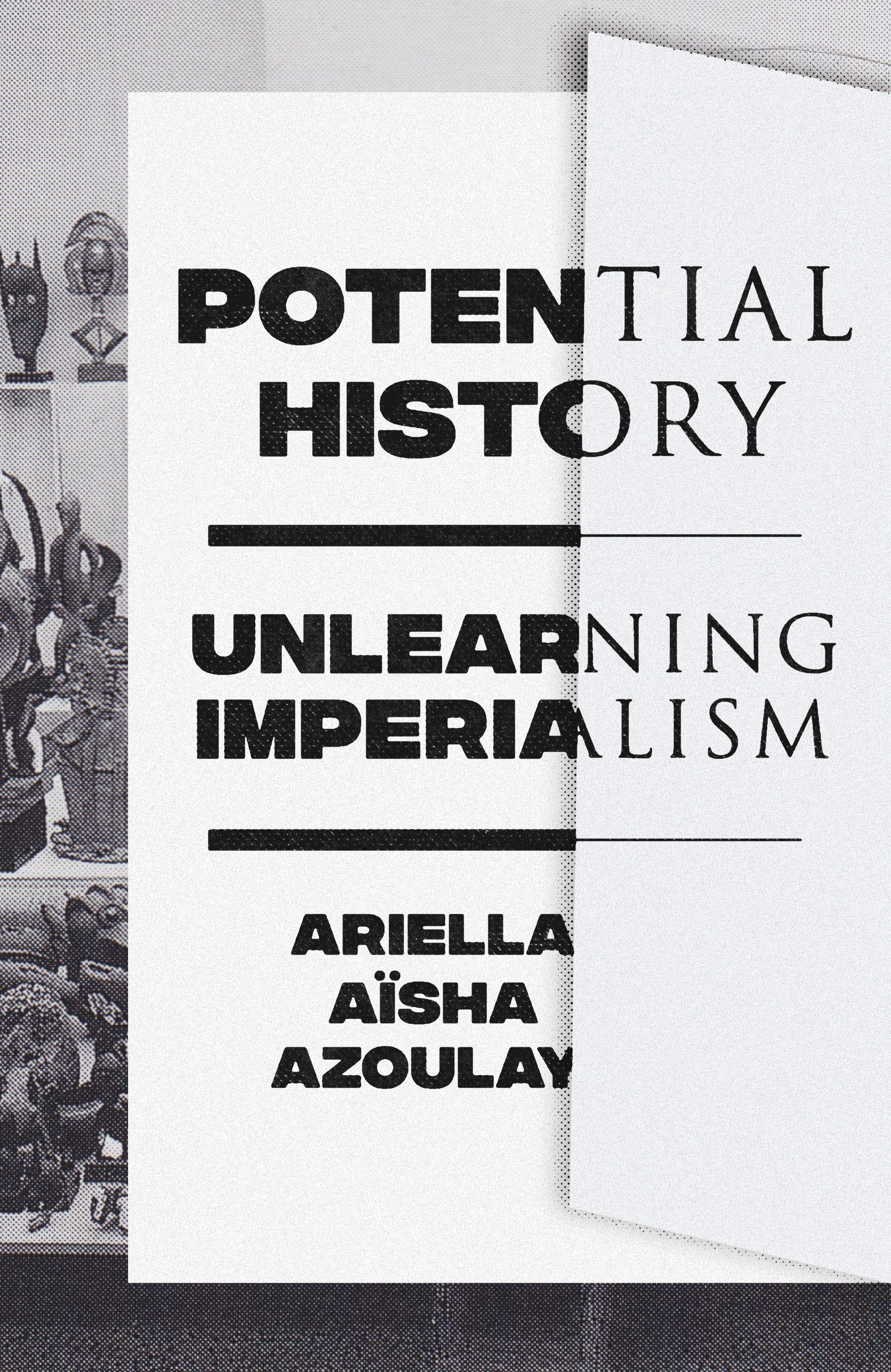
Potential History A passionately urgent call for all of us to unlearn imperialism and repair the violent world we share, from one of our most compelling political theorists In this theoretical tour-de-force, renowned scholar Ariella Aïsha Azoulay calls on us to recognize the imperial foundations of knowledge and to refuse its strictures and its many violences. Azoulay argues that the institutions that make our world, from archives and museums to ideas of sovereignty and human rights to history itself, are all dependent on imperial modes of thinking. Imperialism has segmented populations into differentially governed groups, continually emphasized the possibility of progress while it tries to destroy what came before, and voraciously seeks out the new by sealing the past away in dusty archival boxes and the glass vitrines of museums. By practicing what she calls potential history, Azoulay argues that we can still refuse the original imperial violence that shattered communities, lives, and worlds, from native peoples in the Americas at the moment of conquest to the Congo ruled by Belgium's brutal King Léopold II, from dispossessed Palestinians in 1948 to displaced refugees in our own day. In Potential History, Azoulay travels alongside historical companions—an old Palestinian man who refused to leave his village in 1948, an anonymous woman in war-ravaged Berlin, looted objects and documents torn from their worlds and now housed in archives and museums—to chart the ways imperialism has sought to order time, space, and politics. Rather than looking for a new future, Azoulay calls upon us to rewind history and unlearn our imperial rights, to continue to refuse imperial violence by making present what was invented as “past” and making the repair of torn worlds the substance of politics. POLITICAL SCIENCE,Essays

Bland Fanatics A wide-ranging, controversial collection of critical essays on the political mania plaguing the West by one of the most important public intellectuals of our time. In America and in England, faltering economies at home and failed wars abroad have generated a political and intellectual hysteria. It is a derangement manifested in a number of ways: nostalgia for imperialism, xenophobic paranoia, and denunciations of an allegedly intolerant left. These symptoms can be found even among the most informed of Anglo-America. In Bland Fanatics, Pankaj Mishra examines the politics and culture of this hysteria, challenging the dominant establishment discourses of our times. In essays that grapple with the meaning and content of Anglo-American liberalism and its relations with colonialism, the global South, Islam, and “humanitarian†war, Mishra confronts writers such as Jordan Peterson, Niall Ferguson, and Salman Rushdie. He describes the doubling down of an intelligentsia against a background of weakening Anglo-American hegemony, and he explores the commitments of Ta-Nehisi Coates and the ideological determinations of The Economist. These essays provide a vantage point from which to understand the current crisis and its deep origins. POLITICAL SCIENCE,Essays
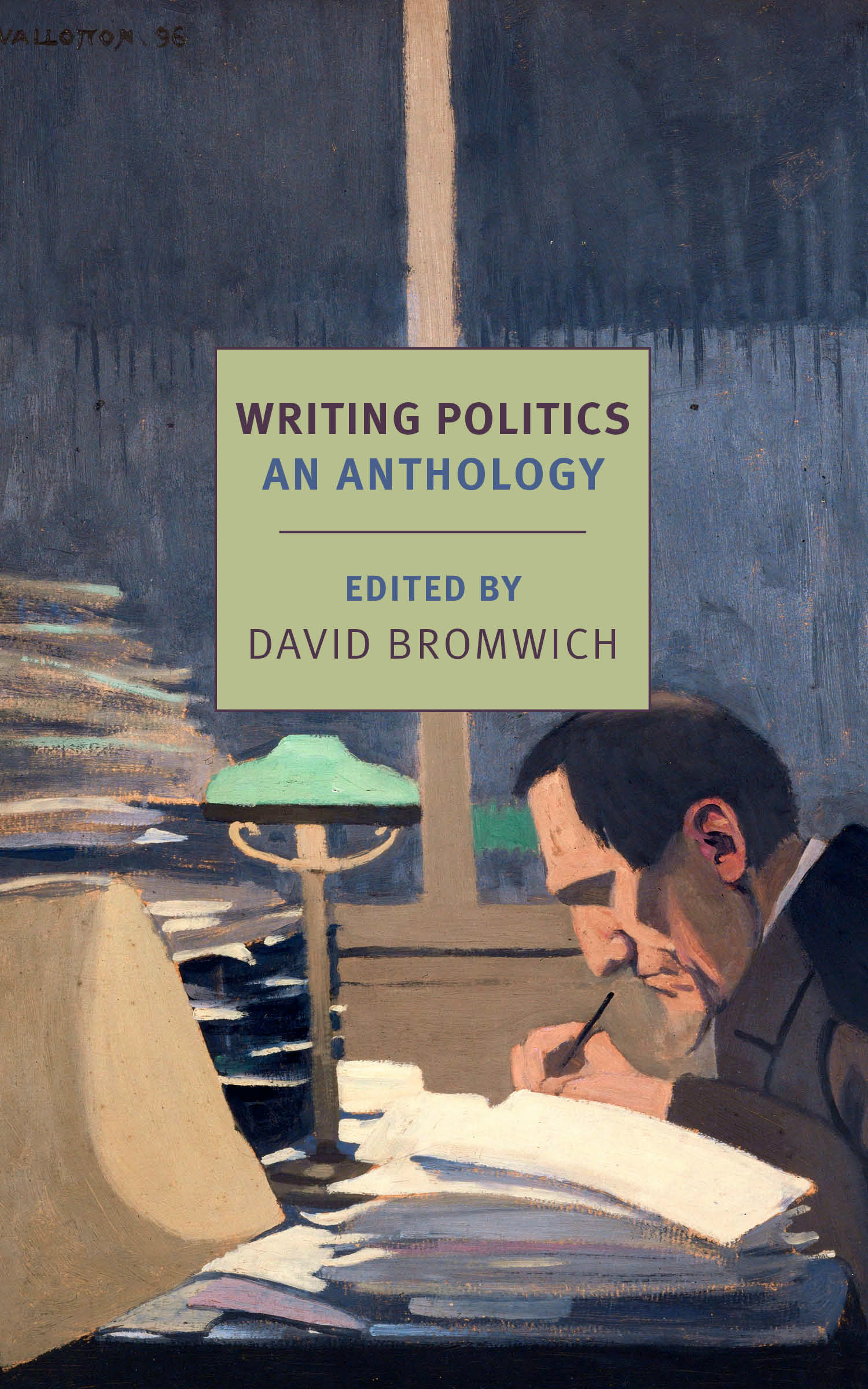
Writing Politics Explore the tradition of the political essay with this brilliant anthology. David Bromwich is one of the most well-informed, cogent, and morally uncompromising political writers on the left today. He is also one of our finest intellectual historians and literary critics. In Writing Politics, Bromwich presents twenty-seven essays by different writers from the beginning of the modern political world in the seventeenth century until recent times, essays that grapple with issues that continue to shape history—revolution and war, racism, women’s rights, the status of the worker, the nature of citizenship, imperialism, violence and nonviolence, among them—and essays that have also been chosen as superlative examples of the power of written English to reshape our thoughts and the world. Jonathan Swift, Edmund Burke, Henry David Thoreau, Harriet Taylor, Abraham Lincoln, George Eliot, W. E. B. Du Bois, Mohandas Gandhi, Virginia Woolf, Martin Luther King, and Hannah Arendt are here, among others, along with a wide-ranging introduction. POLITICAL SCIENCE,Essays

Loud Black Girls An important and timely anthology of black British writing, edited and curated by the authors of the highly acclaimed, ground-breaking Slay In Your Lane. Slay in Your Lane Presents: Loud Black Girls features essays from the diverse voices of twenty established and emerging black British writers. POLITICAL SCIENCE,Essays
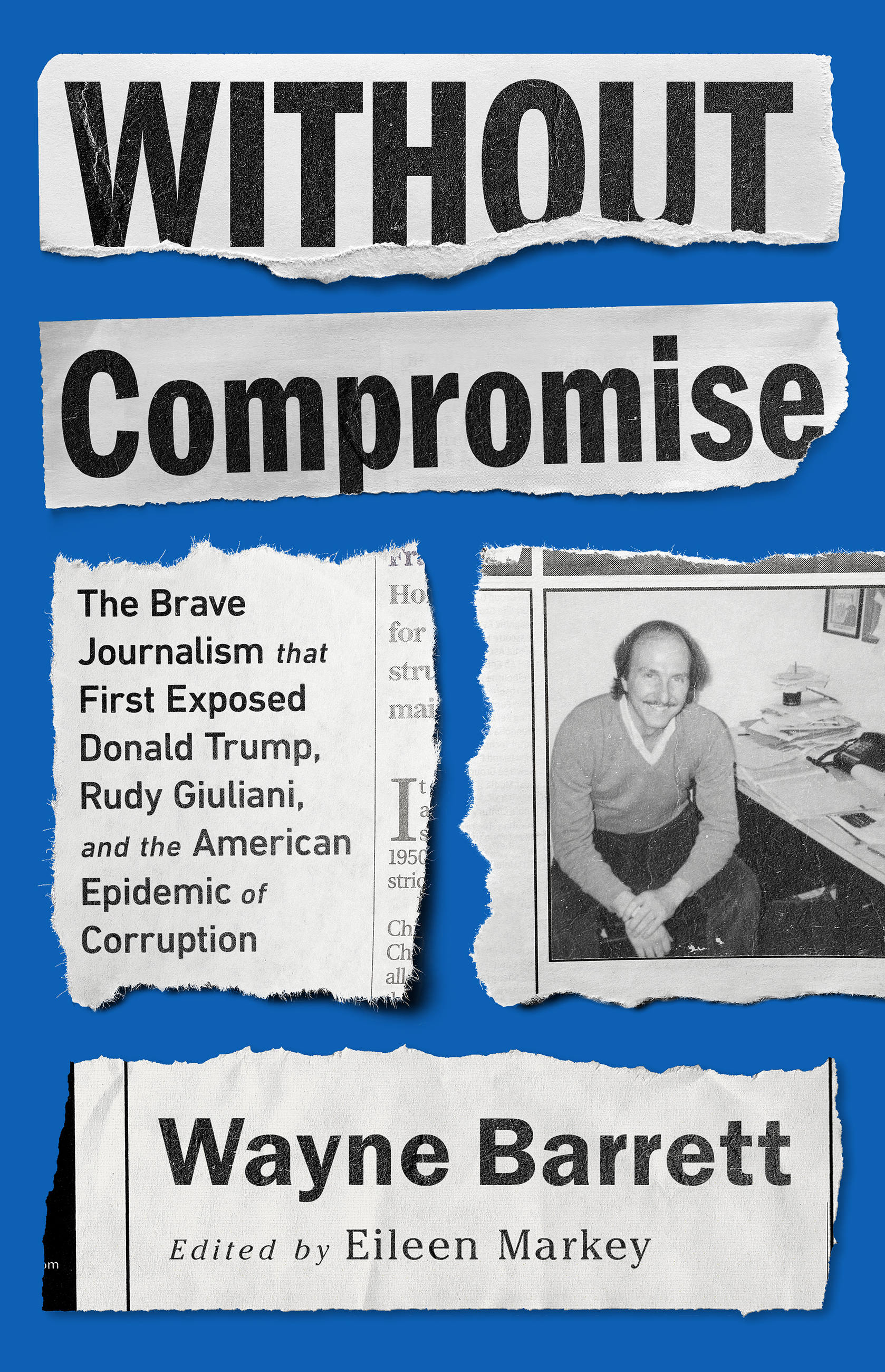
Without Compromise A collection of groundbreaking investigations by Wayne Barrett, the intrepid, muckraking Village Voice journalist who exposed corruption in New York City and beyond. With piercing moral clarity and exacting rigor, Wayne Barrett tracked political corruption in the pages of the Village Voice fact by fact, document by document for 40 years. The first to report on the scams and crooked deals that fueled the rise of Donald Trump in 1979, Barrett went on to expose the shady dealings of small-time slum lords and powerful New York City politicians alike, from Ed Koch to Rudy Giuliani to Michael Bloomberg. Without Compromise is the first anthology of Barrett's investigative work, accompanied by essays from colleagues and those he trained. In an age of lies, fog, and propaganda, when the profession of journalism is degraded by the White House and the industry is under financial threat, Barrett reminds us that facts, when clearly accumulated, are our best defense of democracy. Featuring essays by: Joe Conason Kim Phillips-Fein Errol Louis Gerson Borrero Tom Robbins Tracie McMillan Peter Noel Adam Fifield Jarrett Murphy Andrea Bernstein Jennifer Gonnerman Mac Barrett POLITICAL SCIENCE,Essays

Precarious Life In this profound appraisal of post-September 11, 2001 America, Judith Butler considers the conditions of heightened vulnerability and aggression that followed from the attack on the US, and US retaliation. Judith Butler critiques the use of violence that has emerged as a response to loss, and argues that the dislocation of first-world privilege offers instead a chance to imagine a world in which that violence might be minimized and in which interdependency becomes acknowledged as the basis for a global political community. Butler considers the means by which some lives become grief-worthy, while others are perceived as undeserving of grief or even incomprehensible as lives. She discusses the political implications of sovereignty in light of the prisoners in Guantanamo Bay. She argues against the anti-intellectual current of contemporary US patriotism and the power of censorship during times of war. Finally, she takes on the question of when and why anti-semitism is leveled as a charge against those who voice criticisms of the Israeli state. She counters that we have a responsibility to speak out against both Israeli injustices and anti-semitism, and argues against the rhetorical use of the charge of anti-semitism to quell public debate. In her most impassioned and personal book to date, Judith Butler responds to the current US policies to wage perpetual war, and calls for a deeper understanding of how mourning and violence might instead inspire solidarity and a quest form global justice. POLITICAL SCIENCE,Essays

Midland A collection of revelatory stories from leading journalists between the coasts, offering a perspective on immigration, drug addiction, climate change, and more that you won’t find in the national media. After the 2016 election, the national media fretted over what they could have missed in the middle of the country. Journalists in the middle of the country shook their head at these narratives about Trump Country and the forgotten. Ted Genoways, one of the prominent contributors here, foresaw how close the election would be and in its aftermath put out a public call on Facebook, tagging writers from those midland states, to answer the national media’s puzzlement with their own stories of what had been lying in wait all along. Representing a true cross-section of America, both geographically and ethnically, these writers prepare us for another election cycle by highlighting the true diversity of the American experience. Esther Honig describes the effects of the immigration crackdown in Colorado; C.J. Janovy writes about the challenges of being an LGBTQ+ activist in Kansas; Karen Coates and Valeria Fernández show us the children harvesting our food; and Sydney Boles chronicles a miner’s protest in Kentucky. For readers willing to look at the American experience that the pundits don’t know about or cover, Midland is an invaluable peek into the hearts and minds of largely unheard Americans. POLITICAL SCIENCE,Essays
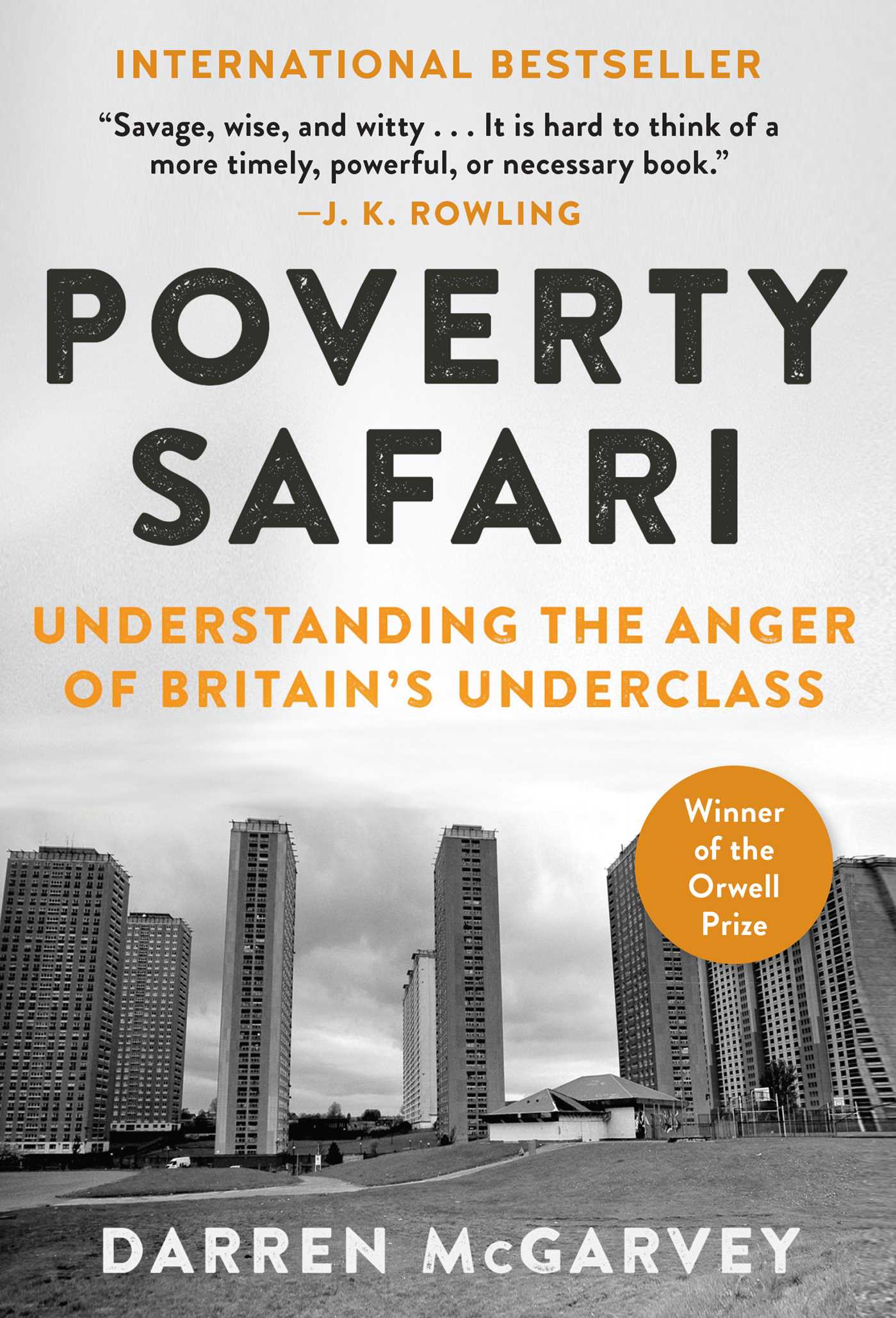
Poverty Safari “Savage, wise, and witty . . . It is hard to think of a more timely, powerful, or necessary book.â€--J. K. Rowling International Bestseller! For readers of Hillbilly Elegy and Evicted, the Orwell Prize–winner that helps us all understand Brexit, Donald Trump, and the connection between poverty and the rise of tribalism in the United Kingdom, in the US, and around the world. Darren McGarvey has experienced poverty and its devastations firsthand. He grew up in a community where violence was a form of currency and has lived through addiction, abuse, and homelessness. He knows why people from deprived communities feel angry and unheard. And he wants to explain . . . So he invites you to come along on a safari of sorts. But not the kind where the wildlife is surveyed from a safe distance. His vivid, visceral, and cogently argued book—part memoir and part polemic—takes us inside the experience of extreme poverty and its stresses to show how the pressures really feel and how hard their legacy is to overcome. Arguing that both the political left and right misunderstand poverty as it is actually lived, McGarvey sets forth what everybody—including himself—could do to change things. Razor-sharp, fearless, and brutally honest, Poverty Safari offers unforgettable insight into conditions in modern Britain, including what led to Brexit—and, beyond that, into issues of inequality, tribalism, cultural anxiety, identity politics, the poverty industry, and the resentment, anger, and feelings of exclusion and being left behind that have fueled right-wing populism and the rise of ethno-nationalism. POLITICAL SCIENCE,Essays

On Secrets On June 4, Federal Police raided the home of Walkley award-winning journalist Annika Smethurst, changing her life forever. Police claim they were investigating the publication of classified information, her employer called it a 'dangerous act of intimidation', Smethurst believes she was simply doing her job. Smethurst became the accidental poster woman for press freedom as politicians debated the merits of police searching through her underwear drawer. In On Secrets she will discuss the impact this invasion has had on her life, and examine the importance of press freedom. POLITICAL SCIENCE,Essays

There Is No Outside An urgent collection of essays on the global pandemic, from n+1 and Verso Books A collaboration between the renowned magazine of literature and politics, n+1, and Verso Books, this collection tracks the course of Covid-19 across the circuits of global capital to New York’s prisons and emergency rooms, Los Angeles’s homeless encampments, and the migrant camps in Greece; and into the intimate spaces of our homes, our ideas of how to live, and into our bodies and cells. We hear from sex workers without work and sailors quarantined on their ships, witness the pandemic from the quiet devastation of upstate New York and quarantined Rome as well as the streets of Delhi, Kashmir, and London and the emergency room of a New York City hospital. From some of the most exciting and thoughtful young writers around the globe, There Is No Outside explores the unspooling wreckage of Covid-19 and helps us imagine what might come in the aftermath. With contributions from Andrew Liu, Rachel Ossip, Gabriel Winant, Francesco Pacifico, Sarah Resnick, Teresa Thornhill, Shigraf Zahbi, Debjani Bhattacharyya, Banu Subramaniam, Mark Krotov, Karim Sariahmed, Ana Cecilia Alvarez, Jack Norton, Laleh Khalili, Aaron Timms, Sonya Aragon, Sean Cooper, Chloe Aridjis, and Marco Roth, and with an introduction by Jessie Kindig. POLITICAL SCIENCE,Essays
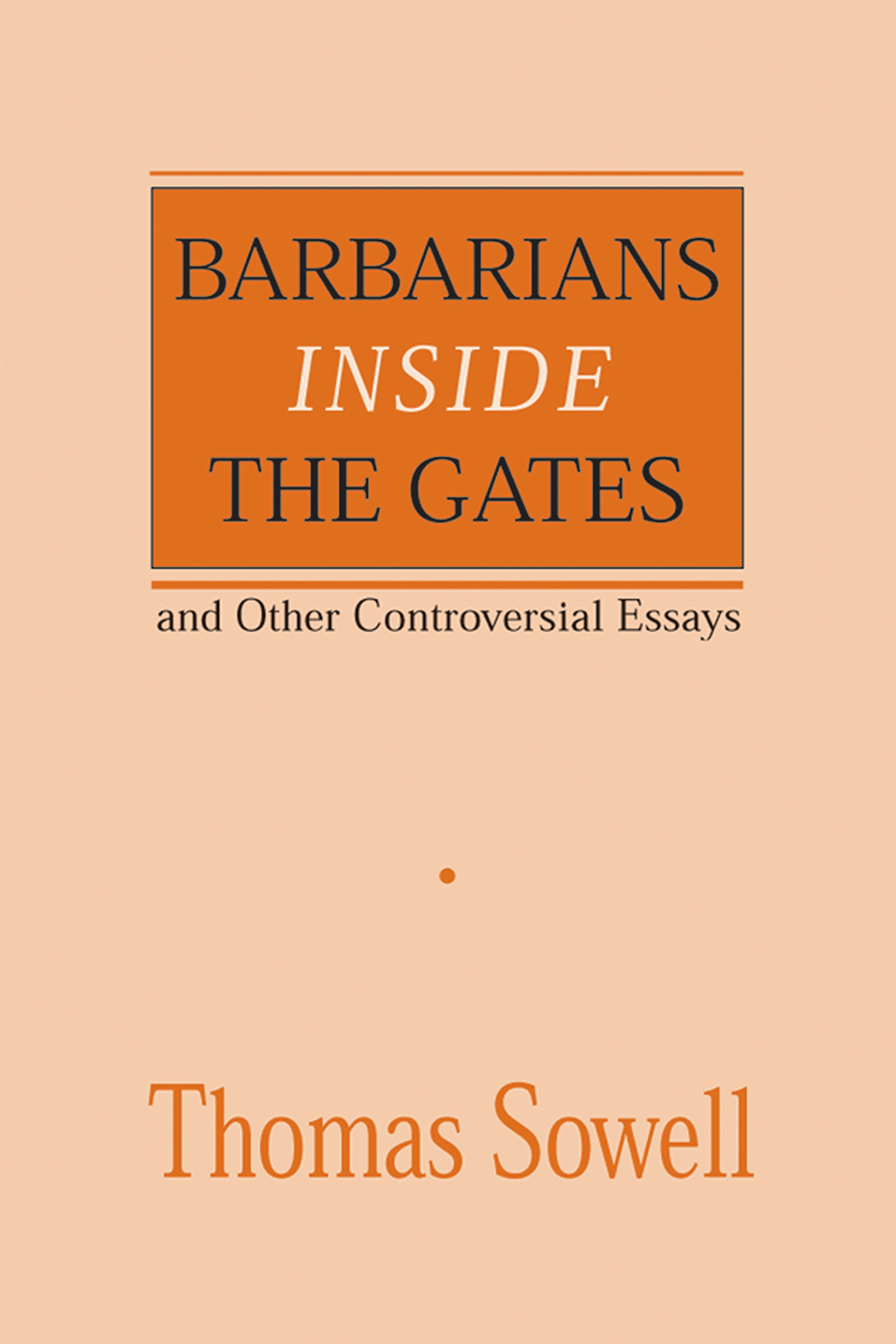
Barbarians inside the Gates and Other Controversial Essays A collection of essays that discusses such issues as the media, immigration, the minimum wage and multiculturalism. POLITICAL SCIENCE,Essays

No Future for You A new collection on carnival hokum and magical thinking in post-apocalypse America—brought to you by The Baffler. There's never been a better time to be outside the consensus—and if you don't believe it, then peer into these genre-defining essays from The Baffler, the magazine that's been blunting the cutting edge of American culture and politics for a quarter of a century. Here's Thomas Frank on the upward-falling cult of expertise in Washington, D.C., where belonging means getting the major events of our era wrong. Here's Rick Perlstein on direct mail scams, multilevel marketing, and the roots of right-wing lying. Here's John Summers on the illiberal uses of innovation in liberal Cambridge, Massachusetts. And here's David Graeber sensing our disappointment in new technology. (We expected teleportation pods, antigravity sleds, and immortality drugs. We got LinkedIn, which, as Ann Friedman writes here, is an Escher staircase masquerading as a career ladder.) Packed with hilarious, scabrous, up to-the-minute criticism of the American comedy, No Future for You debunks “positive thinking” bromides and business idols. Susan Faludi debunks Facebook executive Sheryl Sandberg's phony feminist handbook, Lean In. Evgeny Morozov wrestles “open source” and “Web 2.0” and other pseudorevolutionary meme-making down to the ground. Chris Lehmann writes the obituary of the Washington Post, Barbara Ehrenreich goes searching for the ungood God in Ridley Scott's film Prometheus, Heather Havrilesky reads Fifty Shades of Grey, and Jim Newell investigates the strange and typical case of Adam Wheeler, the student fraud who fooled Harvard and, unlike the real culprits, went to jail. No Future for You offers the counternarrative you've been missing, proof that dissent is alive and well in America. Please be warned, however. The writing that follows is polemical in nature. It may seek to persuade you of something. Copublished with The Baffler. Contributors Chris Bray, Mark Dancey, Barbara Ehrenreich, Susan Faludi, Thomas Frank, Ann Friedman, James Griffioen, David Graeber, A. S. Hamrah, Heather Havrilesky, Chris Lehmann, Rhonda Lieberman, Anne Elizabeth Moore, Evgeny Morozov, Jim Newell, Rick Perlstein, John Summers, Maureen Tkacik POLITICAL SCIENCE,Essays
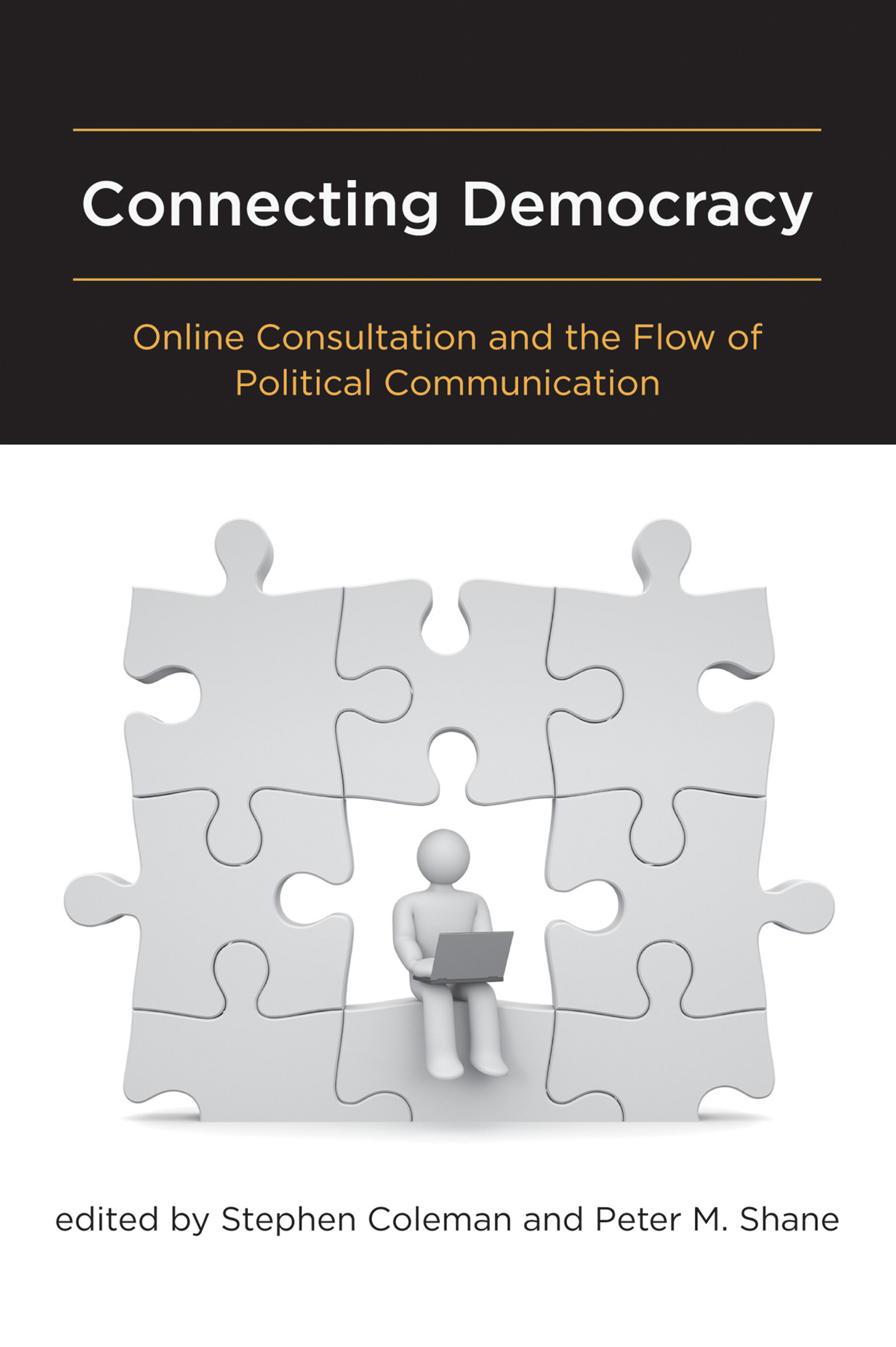
Connecting Democracy An investigation of the effect of government online forums on democratic practices in the United States and Europe. The global explosion of online activity is steadily transforming the relationship between government and the public. The first wave of change, “e-government,” enlisted the Internet to improve management and the delivery of services. More recently, “e-democracy” has aimed to enhance democracy itself using digital information and communication technology. One notable example of e-democratic practice is the government-sponsored (or government-authorized) online forum for public input on policymaking. This book investigates these “online consultations” and their effect on democratic practice in the United States and Europe, examining the potential of Internet-enabled policy forums to enrich democratic citizenship. The book first situates the online consultation phenomenon in a conceptual framework that takes into account the contemporary media environment and the flow of political communication; then offers a multifaceted look at the experience of online consultation participants in the United States, the United Kingdom, and France; and finally explores the legal architecture of U.S. and E. U. online consultation. As the contributors make clear, online consultations are not simply dialogues between citizens and government but constitute networked communications involving citizens, government, technicians, civil society organizations, and the media. The topics examined are especially relevant today, in light of the Obama administration's innovations in online citizen involvement. POLITICAL SCIENCE,Essays
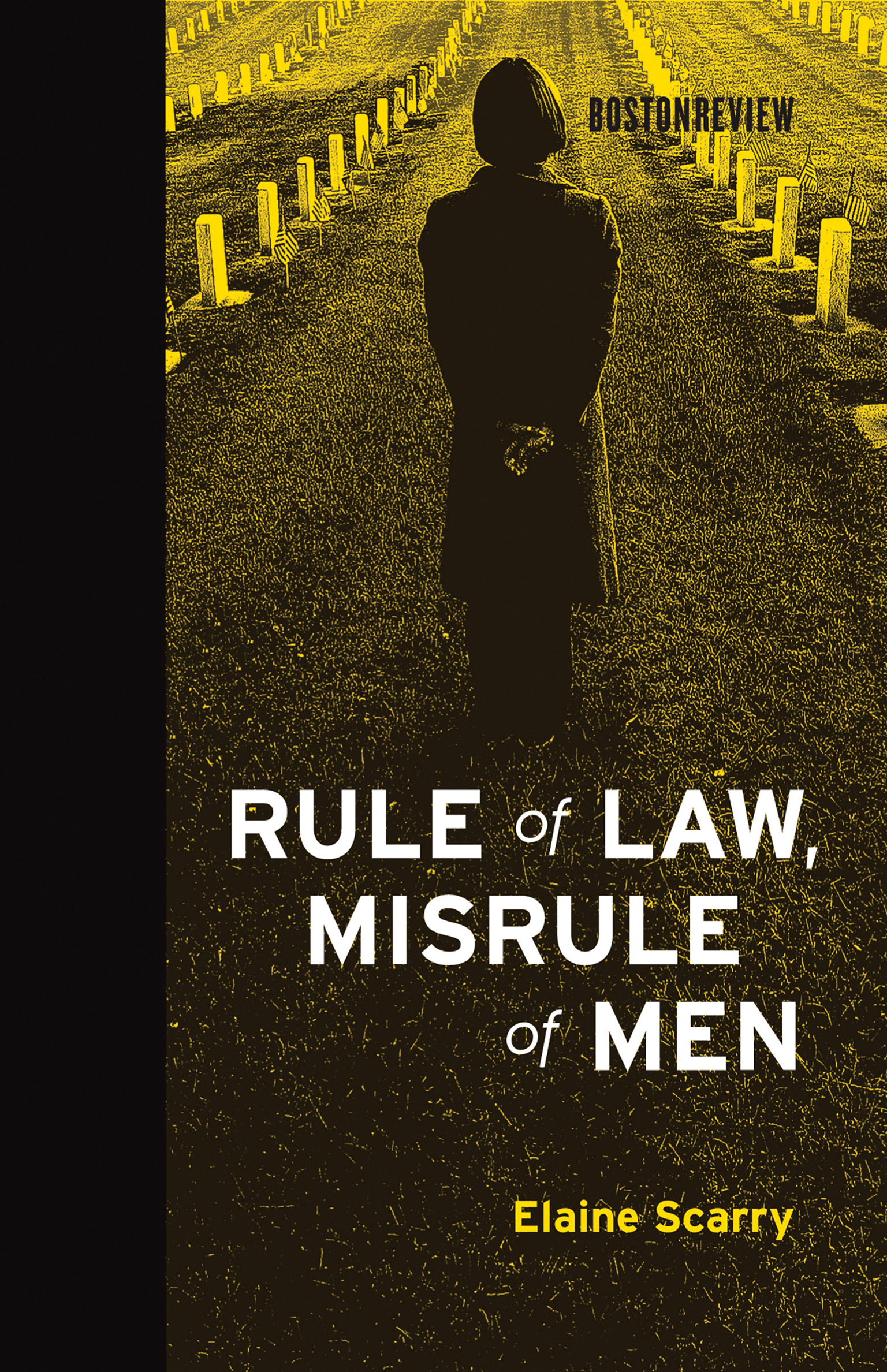
Rule of Law, Misrule of Men A passionate call for citizen action to uphold the rule of law when government does not. This book is a passionate call for citizen action to uphold the rule of law when government does not. Arguing that post-9/11 legislation and foreign policy severed the executive branch from the will of the people, Elaine Scarry in Rule of Law, Misrule of Men offers a fierce defense of the people's role as guarantor of our democracy. She begins with the groundswell of local resistance to the 2001 Patriot Act, when hundreds of towns, cities, and counties passed resolutions refusing compliance with the information-gathering the act demanded, showing that citizens can take action against laws that undermine the rights of citizens and noncitizens alike. Scarry, once described in the New York Times Sunday Magazine as “known for her unflinching investigations of war, torture, and pain,” then turns to the conduct of the Iraqi occupation, arguing that the Bush administration led the country onto treacherous moral terrain, violating the Geneva Conventions and the armed forces' own most fundamental standards. She warns of the damage done to democracy when military personnel must choose between their own codes of warfare and the illegal orders of their civilian superiors. If our military leaders uphold the rule of law when civilian leaders do not, might we come to prefer them? Finally, reviewing what we know now about the Bush administration's crimes, Scarry insists that prosecution—whether local, national, or international—is essential to restoring the rule of law, and she shows how a brave town in Vermont has taken up the challenge. Throughout the book, Scarry finds hope in moments where citizens withheld their consent to grievous crimes, finding creative ways to stand by their patriotism. POLITICAL SCIENCE,Essays

Please Don't Remain Calm A lucid deconstruction of the politics and public figures shaping the social, financial, and military disasters of our times. This selection of Michael Kinsley's trenchant editorial writing in Slate (and elsewhere) since 1995 covers the end of the Clinton era (Monica, impeachment, etc.) and two terms of George W. Bush (9/11, the War on Terror, Iraq, etc.).During this time Kinsley left Washington for Seattle and founded Slate, was opinion editor of the Los Angeles Times, underwent brain surgery for Parkinson's disease, and had other adventures that are reflected here. Although mostly about politics, there are articles and essays about other things, such as the future of newspapers, the existence of God, and why power women love Law and Order.This is the work of a writer at the top of his form. Kinsley's wit is a weapon that any talk-show host or elected blowhard should envy and fear, and the reader will cherish his sense of humor, which enlivens even the toughest subject matter. POLITICAL SCIENCE,Essays
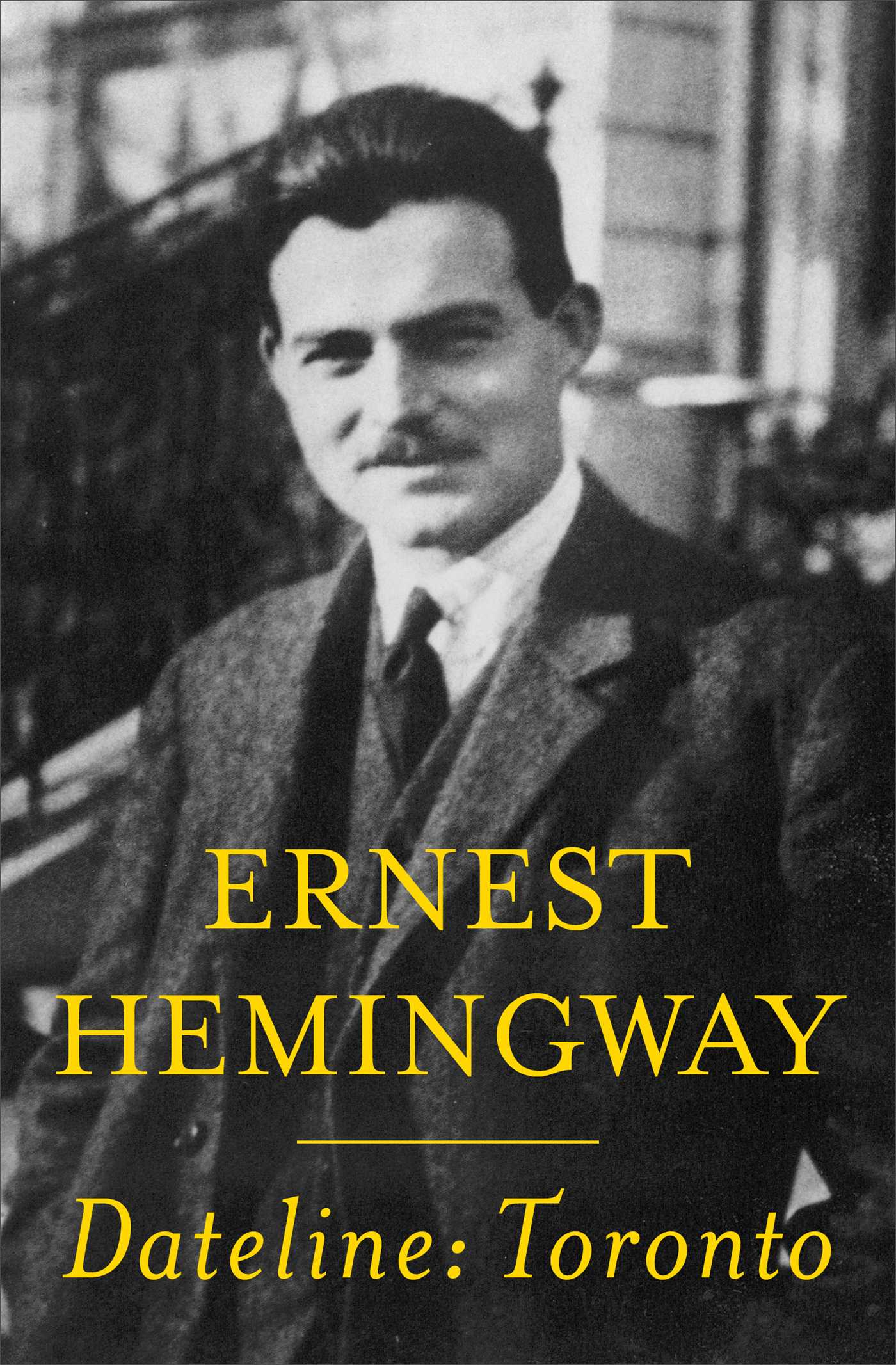
Dateline Dateline: Toronto collects all 172 pieces that Hemingway published in the Star, including those under pseudonyms. Hemingway readers will discern his unique voice already present in many of these pieces, particularly his knack for dialogue. It is also fascinating to discover early reportorial accounts of events and subjects that figure in his later fiction. As William White points out in his introduction to this work, "Much of it, over sixty years later, can still be read both as a record of the early twenties and as evidence of how Ernest Hemingway learned the craft of writing." The enthusiasm, wit, and skill with which these pieces were written guarantee that Dateline: Toronto will be read for pleasure, as excellent journalism, and for the insights it gives to Hemingway's works. POLITICAL SCIENCE,General
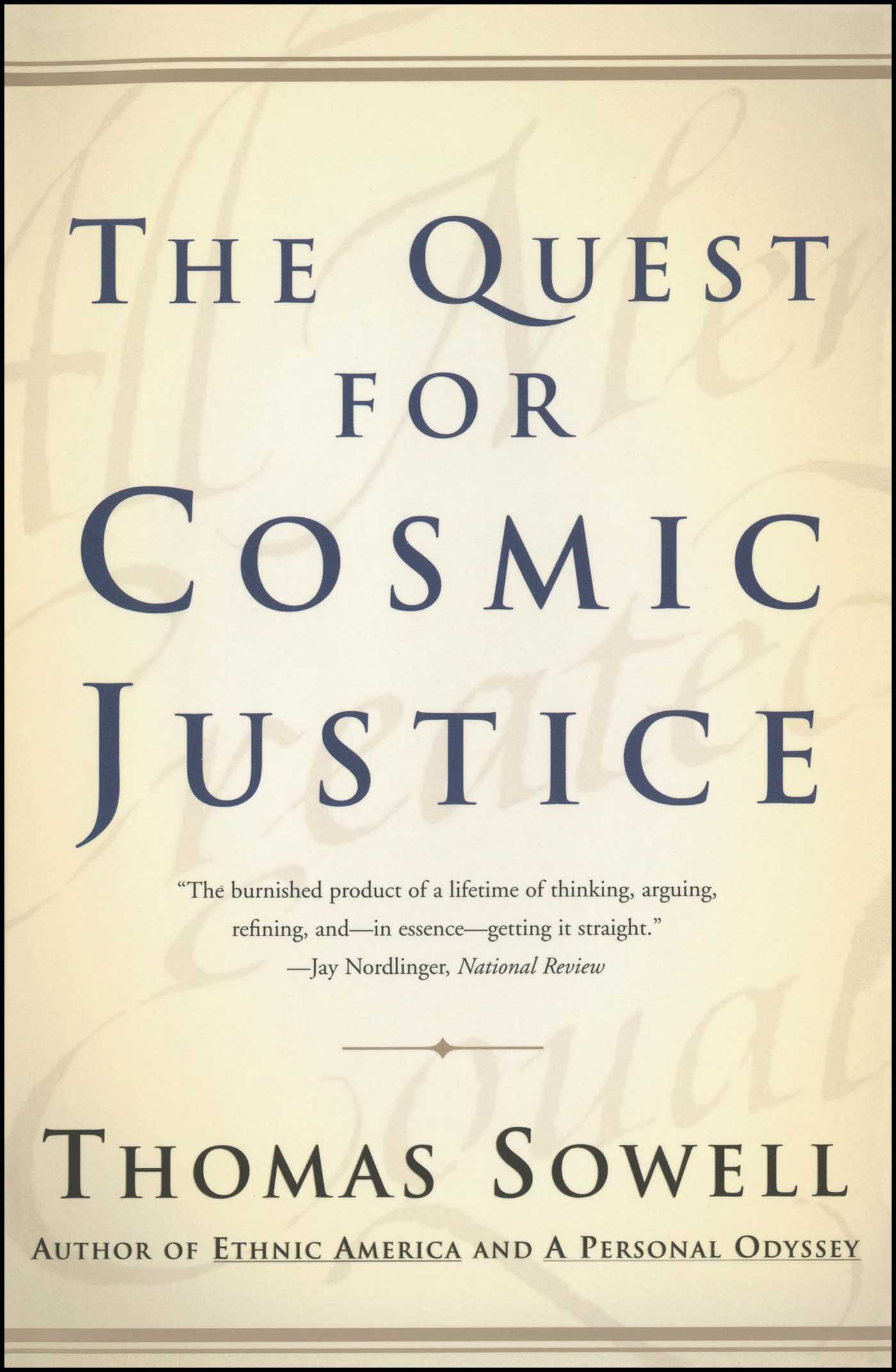
The Quest for Cosmic Justice This book is about the great moral issues underlying many of the headline-making political controversies of our times. It is not a comforting book but a book about disturbing and dangerous trends. The Quest for Cosmic Justice shows how confused conceptions of justice end up promoting injustice, how confused conceptions of equality end up promoting inequality, and how the tyranny of social visions prevents many people from confronting the actual consequences of their own beliefs and policies. Those consequences include the steady and dangerous erosion of fundamental principles of freedom -- amounting to a quiet repeal of the American revolution. The Quest for Cosmic Justice is the summation of a lifetime of study and thought about where we as a society are headed -- and why we need to change course before we do irretrievable damage. POLITICAL SCIENCE,General
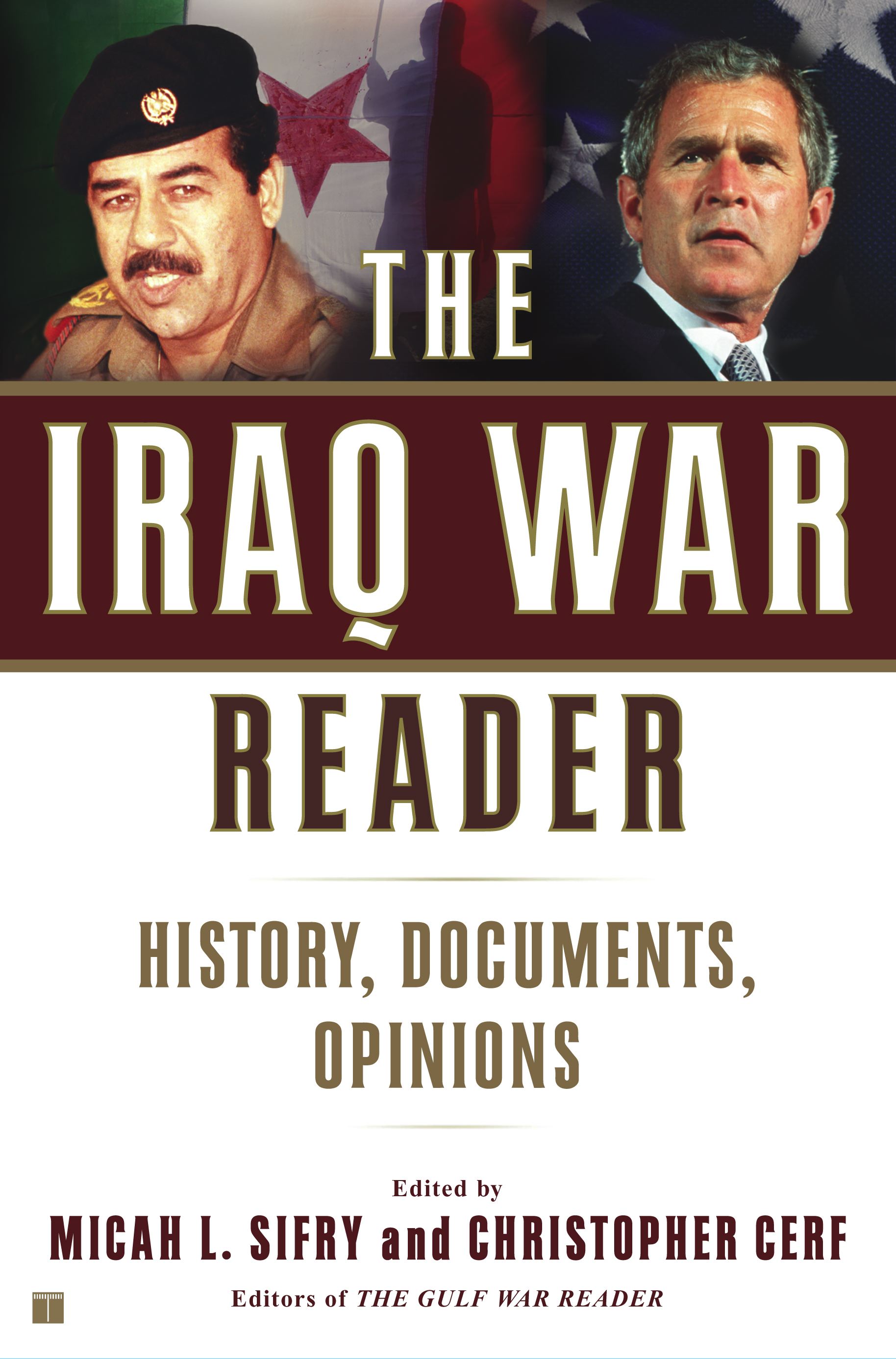
The Iraq War Reader Despite the torrent of coverage devoted to war with Iraq, woefully little attention has been paid to the history of the region, the policies that led to the conflict, and the daunting challenges that will confront America and the Middle East once the immediate crisis has ended. In this collection, Micah L. Sifry and Christopher Cerf, coeditors of the acclaimed Gulf War Reader, have assembled essays and documents that present an eminently readable, up-to-the-moment guide -- from every imaginable perspective -- to the continuing crisis in the Gulf and Middle East. Here, in analysis and commentary from some of the world's leading writers and opinion makers -- and in the words of the key participants themselves -- is the engrossing saga of how oil economics, power politics, dreams of empire, nationalist yearnings, and religious fanaticism -- not to mention naked aggression, betrayal, and tragic miscalculation -- have conspired to bring us to the fateful collision of the West and the Arab world over Iraq. Contributors include: Fouad Ajami George W. Bush Richard Butler John le Carré Noam Chomsky Ann Coulter Thomas Friedman Al Gore Seymour Hersh Christopher Hitchens Arianna Huffington Saddam Hussein Terry Jones Robert Kagan Charles Krauthammer William Kristol Nicholas Lemann Kanan Makiya Kevin Phillips Kenneth Pollack Colin Powell Condoleezza Rice Arundhati Roy Edward Said William Safire Jonathan Schell Susan Sontag George Will POLITICAL SCIENCE,General
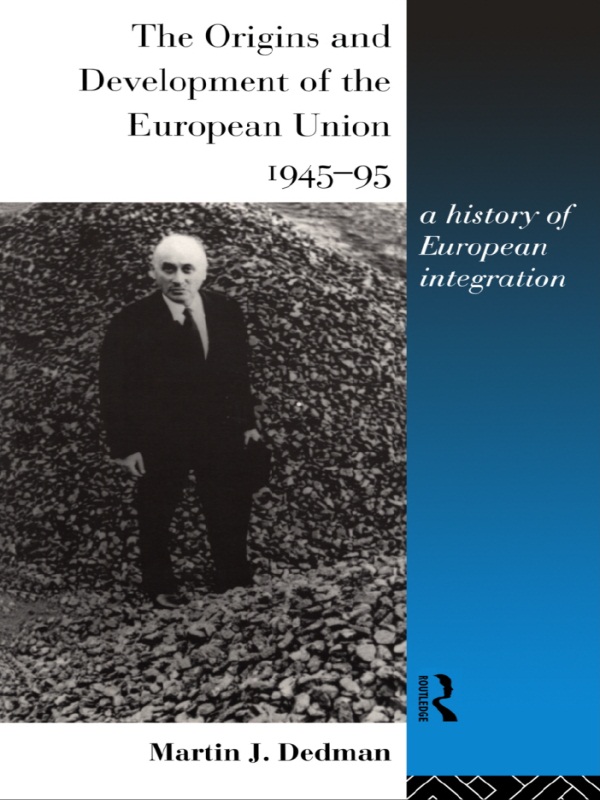
The Origins and Development of the European Union 1945-1995 This friendly, concise and up-to-date introduction to the European Union is essential reading for those new to the study of Europe. It shows students clearly why the European Union is so important for an understanding of the politics of the second half of the twentieth century. Martin Dedman:* provides a general history of European unity and integration from 1945-1995* provides an essential clarification of terms and definitions* outlines the three major schools of thought regarding the causes of European integration* considers the economic and political reasons for establishing supranational organisations* discusses other European organisations created since 1945* traces all the key events since 1945 including the Maastricht Treaty and the movement towards European Economic and Monetary Union. POLITICAL SCIENCE,General
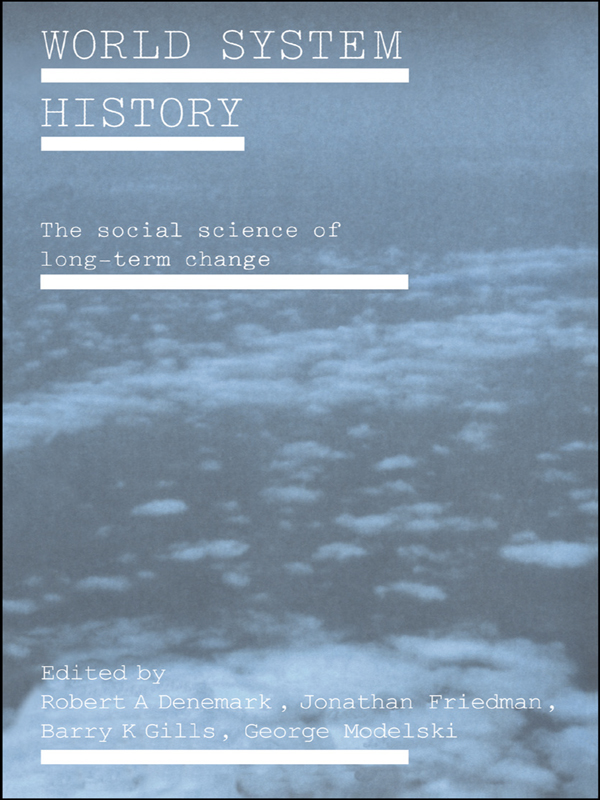
World System History This extraordinary book presents a refreshing and innovative overview of the changes to the global system over the last 5000 years. Featuring renowned contributors - each specialists in their field - this is the only volume to offer so co-ordinated a study of continuity and change in the global social, economic and political system. Key areas covered include: * International Political Economy - Robert A. Denemark* Archaeology - Jonathan Freidman* Economic development - Andre Gunder Frank* History - George Modelski* Sociology - Christopher Chase-Dunn POLITICAL SCIENCE,General

Terrorism and International Law The proliferation in terrorist activity has provoked an increase in the body of law, both at national and international level, which has sought to counter and prevent it. The bodies involved in this process range from the UN Security Council to government legislatures. This book is the first to address, in one volume, the wide variety of responses to terrorism as they exist in both international and domestic contexts. It also represents the first ever comprehensive collection of documents referring to terrorism which are to be found in the laws of the UK and France as well as in international law. Terrorism and International Law comprises contributions by thirteen well-known authorities in the areas of international, French and UK law, and is divided into four main sections: international cooperation against terrorism, the French and British responses to terrorism, the limits of state action and a documentary supplement. The contributors have sought to show how international and domestic law can be used together to combat the multi-faceted problems which terrorism raises. The issue of human rights is also discussed with particular reference to the jurisprudence of the European Commission and Court of Human Rights. The fourth documentary section of the book provides coverage of international treaties, UN resolutions, UK and French legislation, case-law and official statements relating to terrorism.This book provides an invaluable source of commentary and reference material in the area of terrorism and international and domestic law which will be useful for practitioners, diplomats, students and teachers. POLITICAL SCIENCE,General

Confronting Right Wing Extremism and Terrorism in the USA This book examines the response to right-wing extremism in the US from both the government and non-governmental organisations. It provides a detailed portrait of the contemporary extreme right in the US including interviews with several of the movement's leading figures from groups such as the Ku Klux Klan, Militias, American Renaissance and the White Aryan Resistance. The author also explains how the activities of these racist groups have been curbed due to the campaigning efforts of anti-racist and anti-fascist watchdogs who have helped to shape and influence government policy. POLITICAL SCIENCE,General

The One-Hour Activist No matter what your political persuasion, The One-Hour Activist is your guide to influencing lawmakers, candidates, and reporters. The One-Hour Activist reveals fifteen powerful, proven grassroots actions that persuade lawmakers and candidates to see things your way. Each action is designed to grab the attention of your representatives and build relationships that serve your issues over the long run. And each action takes less than an hour to complete, so you can make a difference without giving up your life! The One-Hour Activist is packed with insider advice from elected officials, professional organizers, lobbyists, and journalists who share state-of-the-art tips for getting your message across. Real-life examples of effective letters, e-mail, phone calls, public testimony, and news story pitches from concerned citizens just like you illustrate the actions. POLITICAL SCIENCE,General
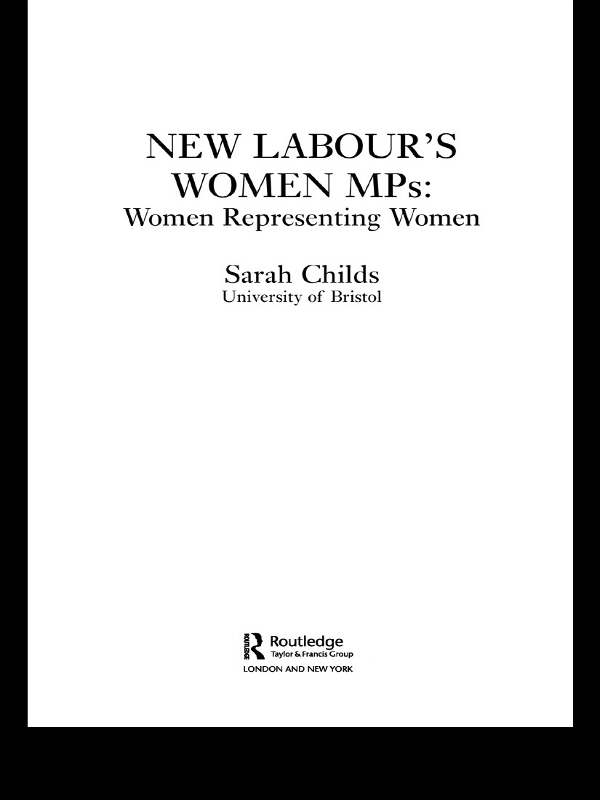
New Labour's Women MPs It was not long after the election of a record number of women to the House of Commons in 1997 that the backlash began. The criticism was all-encompassing: they wore the wrong clothes, they voted the wrong way and they were concerned with the wrong issues. Above all, they were accused of failing to make difference, to have failed women, and were dismissed by some as ‘Blair’s Babes’. Drawing on in-depth interviews with more than half of the new Labour women MPs, Sarah Childs reveals how these women actually experienced being MPs, and explores whether they acted for and like women – in their constituencies, in parliament and in government. She presents important insights into theories of women’s political representation, showing that the relationship between women’s descriptive and substantive representation is complicated, that party and gender identities are crucial, that women’s differences must be acknowledged and that it might not always be possible for women representatives to act for women even if they want to. Including a key section on women’s selection for parliament; whether women MPs act as role models; why it is important that women should be present in politics; as well as exploring in depth the subject of women’s substantive representation, New Labour’s Women MPs is essential reading for all those interested in women and politics, legislative studies, political behaviour and representation. POLITICAL SCIENCE,General
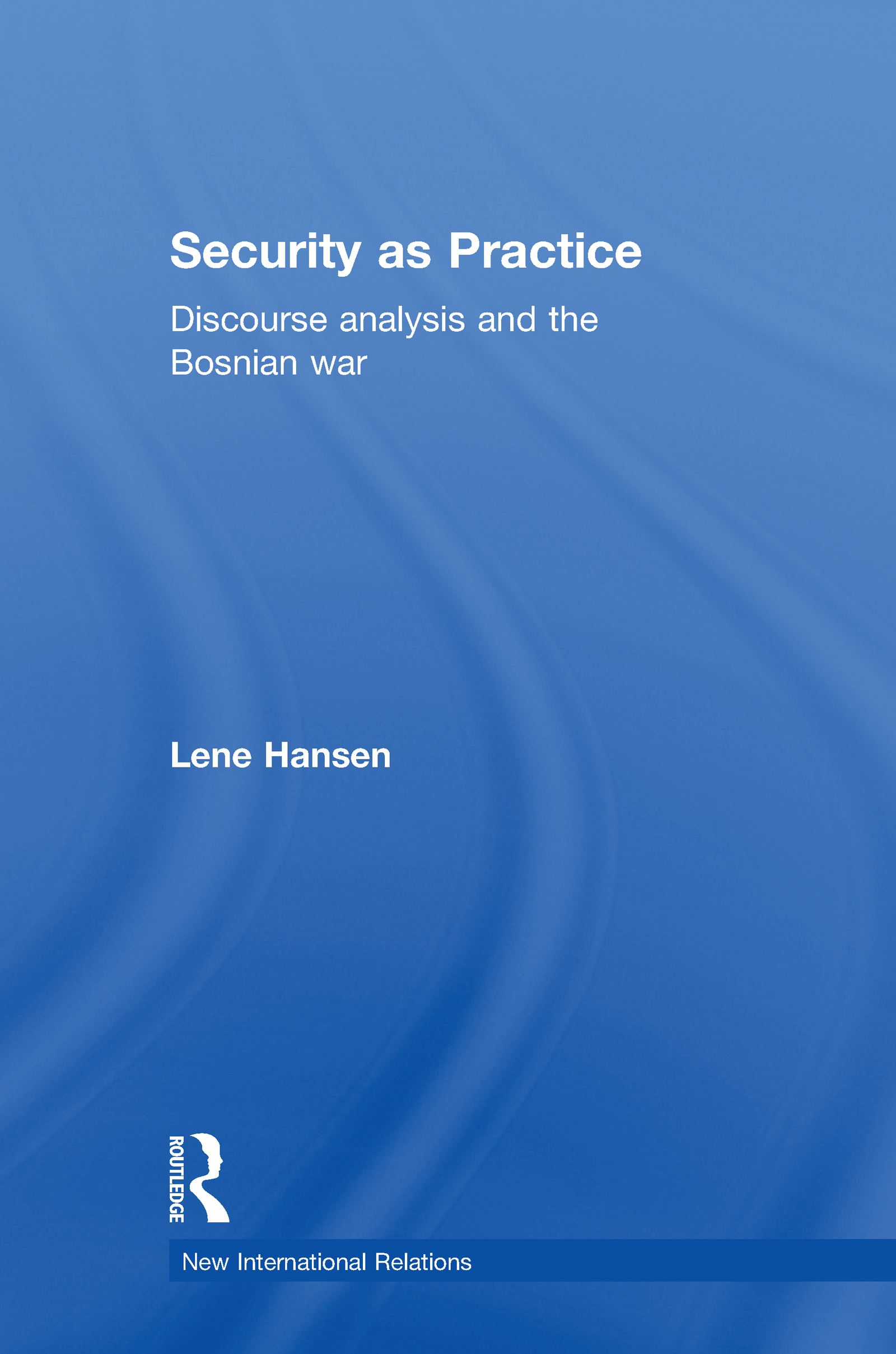
Security as Practice This important text offers a full and detailed account of how to use discourse analysis to study foreign policy. It provides a poststructuralist theory of the relationship between identity and foreign policy and an in-depth discussion of the methodology of discourse analysis. Part I offers a detailed discussion of the concept of identity, the intertextual relationship between official foreign policy discourse and oppositional and media discourses and of the importance of genres for authors' ability to establish themselves as having authority and knowledge. Lene Hansen devotes particular attention to methodology and provides explicit directions for how to build discourse analytical research designs Part II applies discourse analytical theory and methodology in a detailed analysis of the Western debate on the Bosnian war. This analysis includes a historical genealogy of the Western construction of the Balkans as well as readings of the official British and American policies, the debate in the House of Commons and the US Senate, Western media representations, academic debates and travel writing and autobiography. Providing an introduction to discourse analysis and critical perspectives on international relations, this book will be essential reading for students and scholars of international relations, discourse analysis and research methodology. POLITICAL SCIENCE,General

Britain, Nasser and the Balance of Power in the Middle East, 1952-1977 A multi-archival documentary history of British policy towards Nasser's Egypt under the Churchill, Eden, Macmillan, Home and Wilson governments. The primary focus of the study is an enquiry into the causes of the Anglo-Egyptian Cold War from 1952 to 1967. POLITICAL SCIENCE,General

The Use and Abuse of Political Asylum in Britain and Germany All European states have the legal right to grant asylum but only Germany is obliged by law to do so. Liza Schuster contributes to the asylum debate primarily in the area of comparative politics in this study of British and German policies on asylum practice. POLITICAL SCIENCE,General

A Social History of Milton Keynes Established in 1967, Milton Keynes is England's largest new city and one of the fastest-growing urban areas in the UK. It is also a suburban city, genuinely liked and appreciated by most of its citizens.For many reasons, however, Milton Keynes is misunderstood, and its valuable recent lessons are mostly ignored in debates about national urban policy. This book discusses the popular and intellectual prejudices that have distorted understandings of the new city. A city is nothing without its people, of course, so Mark Clapson looks at who has moved to Milton Keynes, and discusses their experiences of settling in. He also confronts the common myth of the new city's soullessness with an account of community and association that emphasizes the strength of social interaction there. POLITICAL SCIENCE,General

Plan of Attack Plan of Attack is the definitive account of how and why President George W. Bush, his war council, and allies launched a preemptive attack to topple Saddam Hussein and occupy Iraq. Bob Woodward's latest landmark account of Washington decision making provides an original, authoritative narrative of behind-the-scenes maneuvering over two years, examining the causes and consequences of the most controversial war since Vietnam. Based on interviews with 75 key participants and more than three and a half hours of exclusive interviews with President Bush, Plan of Attack is part presidential history charting the decisions made during 16 critical months; part military history revealing precise details and the evolution of the Top Secret war planning under the restricted codeword Polo Step; and part a harrowing spy story as the CIA dispatches a covert paramilitary team into northern Iraq six months before the start of the war. This team recruited 87 Iraqi spies designated with the cryptonym DB/ROCKSTARS, one of whom turned over the personnel files of all 6,000 men in Saddam Hussein's personal security organization. What emerges are astonishingly intimate portraits: President Bush in war cabinet meetings in the White House Situation Room and the Oval Office, and in private conversation; Dick Cheney, the focused and driven vice president; Colin Powell, the conflicted and cautious secretary of state; Donald Rumsfeld, the controlling war technocrat; George Tenet, the activist CIA director; Tommy Franks, the profane and demanding general; Condoleezza Rice, the ever-present referee and national security adviser; Karl Rove, the hands-on political strategist; other key members of the White House staff and congressional leadership; and foreign leaders ranging from British Prime Minister Blair to Russian President Putin. Plan of Attack provides new details on the intelligence assessments of Iraq's alleged weapons of mass destruction and the planning for the war's aftermath. POLITICAL SCIENCE,General

The European Union as a Global Actor This comprehensive, up to date and theoretically informed text examines the full range of the European Union's external relations including the Common Foreign and Security Policy. It look at the increasingly important part the EU plays in global politics. The authors argue that the EU's significance cannot be grasped by making comparisons with traditional states. Issues covered include:· the status, coherence, consistency and roles of the EU as an actor, and what being an actor means in practice.· how the field of trade relations forms the basis of the EUs activities · the EU in global environmental diplomacy, North-South relations and in relation to the Mediterranean and East/Central Europe· the EUs controversial relationship to the Common Foreign and Security Policy and defence. POLITICAL SCIENCE,General
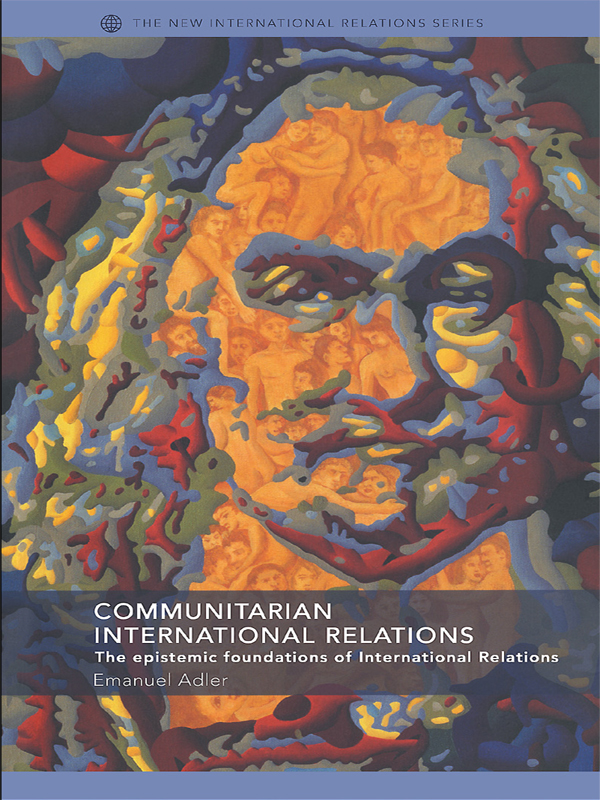
Communitarian International Relations In Emanuel Adler's distinctive constructivist approach to international relations theory, international practices evolve in tandem with collective knowledge of the material and social worlds. This book - comprising a fresh selection of his journal publications, a substantial new introduction, three previously unpublished articles - points IR constructivism in a novel direction, characterized as 'communitarian'. Adler's synthesis does not herald the end of the nation-state; nor does it suggest that agency is unimportant in international life. Rather, it argues that what mediates between individual and state agency and social structures are communities of practice, which are the wellspring and repositories of collective meanings and social practices. The concept of communities of practice casts new light on epistemic communities and security communities, helping to explain why certain ideas congeal into human practices and others do not, and which social mechanisms can facilitate the emergence of normatively better communities. POLITICAL SCIENCE,General
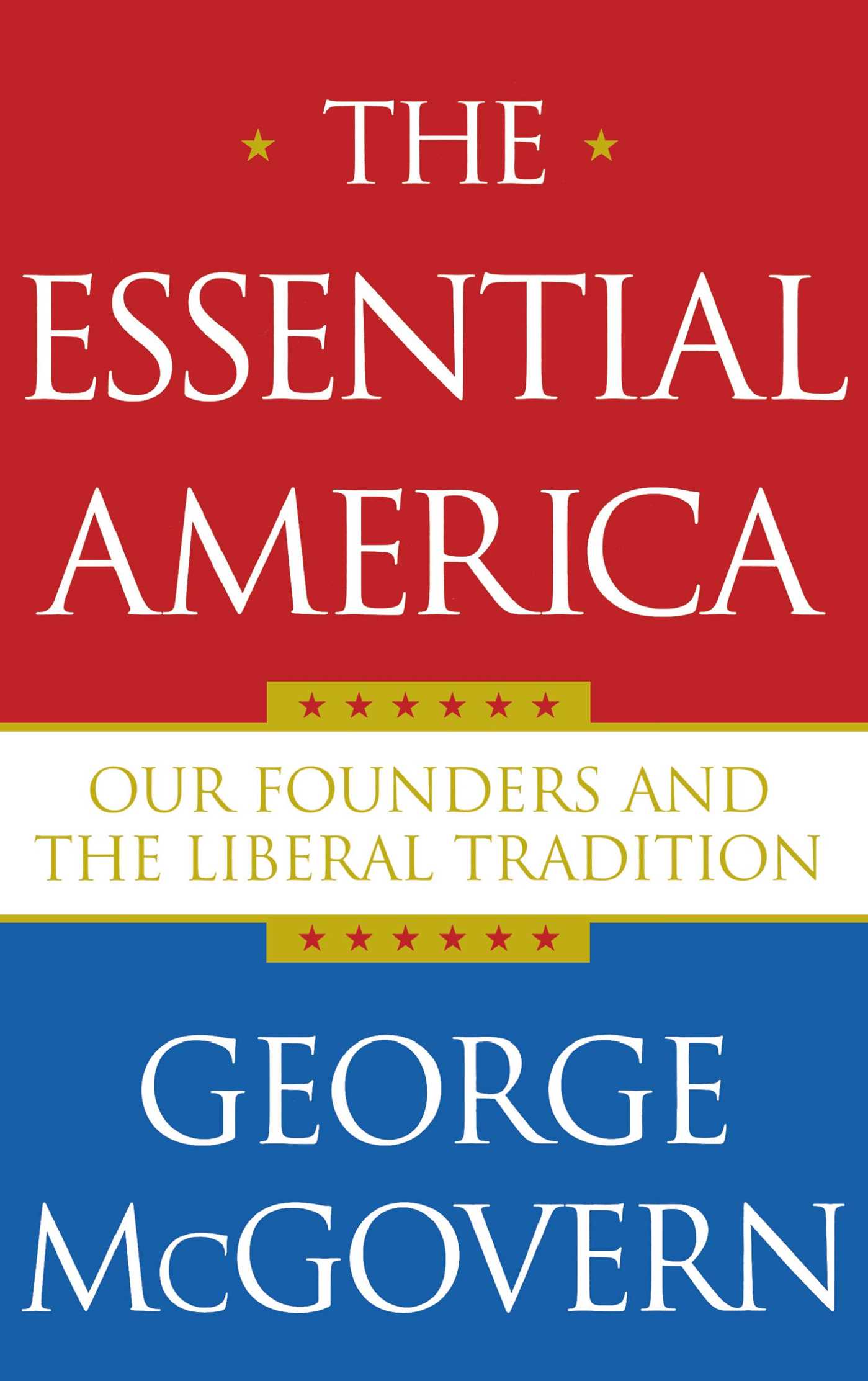
The Essential America Liberalism is the oldest and most enduring American tradition, a philosophy and way of life we inherited from the Founding Fathers. This is the central idea of The Essential America by George McGovern, America's best-known (and most consistent) liberal. Referring us to our moral and spiritual foundations, McGovern not only presents a resounding defense of liberalism as "the most practical and hopeful compass to guide the American ship of state" but offers specific proposals for keeping the tradition vibrant. The Essential America proposes programs for feeding the world's malnourished children. Rather than sending our armies abroad, McGovern spells out policies that confront the causes of terrorism. He proposes cutting our military budget (echoing Dwight D. Eisenhower's powerful warning about the military-industrial complex). He condemns preemptive war, criticizes tax cuts for the rich, and warns against government for the powerful minority. Americans have traditionally stood for progress, generosity, tolerance, and protection of the needy, McGovern states -- as well as for multi- lateralism in foreign policy and "a decent respect for the opinions of mankind." He reminds us that while creative tension between liberalism and conservatism is the genius of American politics, it is the liberals who have been responsible for every forward step in our national history. They built "the Essential America." POLITICAL SCIENCE,General
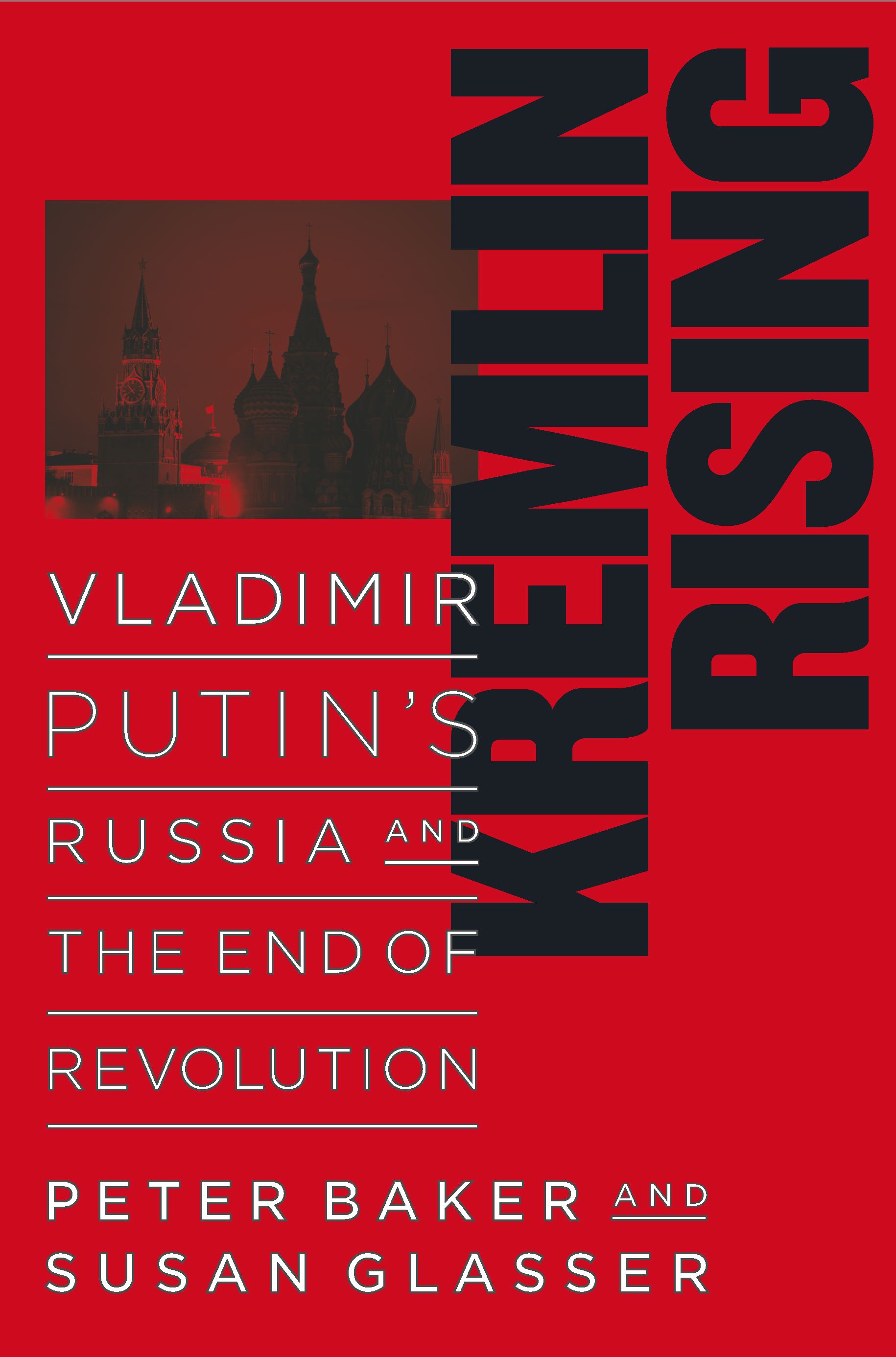
Kremlin Rising In the tradition of Hedrick Smith's The Russians, Robert G. Kaiser's Russia: The People and the Power, and David Remnick's Lenin's Tomb comes an eloquent and eye-opening chronicle of Vladimir Putin's Russia, from this generation's leading Moscow correspondents. With the 1991 collapse of the Soviet Union, Russia launched itself on a fitful transition to Western-style democracy. But a decade later, Boris Yeltsin's handpicked successor, Vladimir Putin, a childhood hooligan turned KGB officer who rose from nowhere determined to restore the order of the Soviet past, resolved to bring an end to the revolution. Kremlin Rising goes behind the scenes of contemporary Russia to reveal the culmination of Project Putin, the secret plot to reconsolidate power in the Kremlin. During their four years as Moscow bureau chiefs for The Washington Post, Peter Baker and Susan Glasser witnessed firsthand the methodical campaign to reverse the post-Soviet revolution and transform Russia back into an authoritarian state. Their gripping narrative moves from the unlikely rise of Putin through the key moments of his tenure that re-centralized power into his hands, from his decision to take over Russia's only independent television network to the Moscow theater siege of 2002 to the "managed democracy" elections of 2003 and 2004 to the horrific slaughter of Beslan's schoolchildren in 2004, recounting a four-year period that has changed the direction of modern Russia. But the authors also go beyond the politics to draw a moving and vivid portrait of the Russian people they encountered -- both those who have prospered and those barely surviving -- and show how the political flux has shaped individual lives. Opening a window to a country on the brink, where behind the gleaming new shopping malls all things Soviet are chic again and even high school students wonder if Lenin was right after all, Kremlin Rising features the personal stories of Russians at all levels of society, including frightened army deserters, an imprisoned oil billionaire, Chechen villagers, a trendy Moscow restaurant king, a reluctant underwear salesman, and anguished AIDS patients in Siberia. With shrewd reporting and unprecedented access to Putin's insiders, Kremlin Rising offers both unsettling new revelations about Russia's leader and a compelling inside look at life in the land that he is building. As the first major book on Russia in years, it is an extraordinary contribution to our understanding of the country and promises to shape the debate about Russia, its uncertain future, and its relationship with the United States. POLITICAL SCIENCE,General
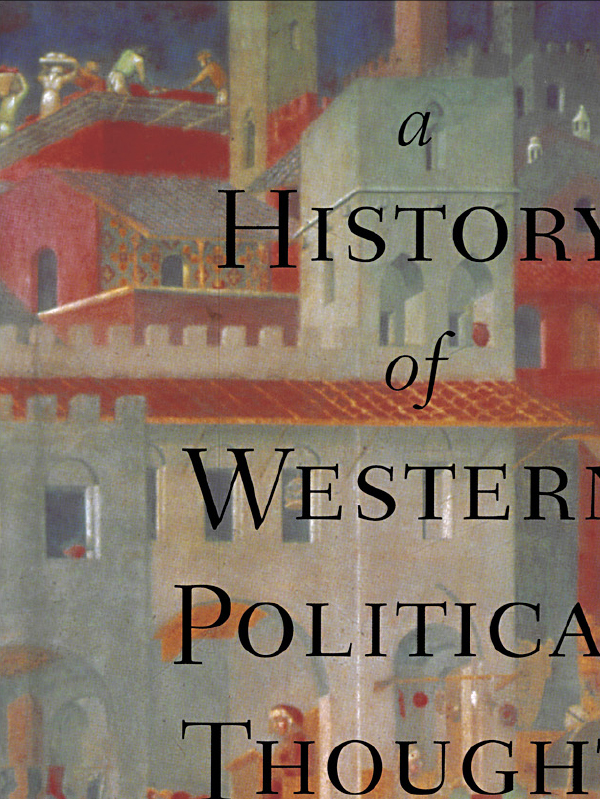
A History of Western Political Thought A History of Western Political Thought is an energetic and lucid account of the most important political thinkers and the enduring themes of the last two and a half millennia. Written with students of the history of political thought in mind, the book:* traces the development of political thought from Ancient Greece to the late twentieth century* focuses on individual thinkers and texts* includes 40 biographies of key political thinkers* offers original views of theorists and highlights those which may have been unjustly neglected* develops the wider themes of political thought and the relations between thinkers over time. POLITICAL SCIENCE,General

Foxes in the Henhouse Like a newly discovered treasure map offering a path to buried riches, Foxes in the Henhouse is a hard-hitting political blueprint for how the Democrats can win again in the South and rural America. The authors document the Republicans' rise in the South and Midwest, expose the hypocrisy that marked their ascent, and offer a take-no-prisoners plan to kick them out. The authors know of what they speak. "Rural strategists" Steve Jarding and Dave "Mudcat" Saunders are famous for securing Democratic victories in places they shouldn't have -- most notably in Mark Warner's successful run for governor of Virginia, a campaign that wasn't afraid to use bluegrass concerts and NASCAR to get the message out. When George W. Bush swept the South clean in 2004, it was the final insult to Jarding and Saunders, two self-proclaimed "bubbas" on a mission to convince their fellow southerners and rural Americans that the GOP's claim of representing "values," patriotism, the sportsmen, and fiscal conservatism is a disastrous farce. In addition to exposing the lies behind the gradual Republican invasion of the hinterland that began in the 1960s, they offer some surprisingly simple strategies for Democrats to capture each of these issues. Among other things, Jarding and Saunders urge Democrats to Quit turning their noses up at the culture of rural America and talk to people where they live Learn how to count when going after votes Show some passion and retaliate when Republicans assassinate their characters Packed with meticulous and shocking research findings; blunt, laugh-out-loud language; and merciless assaults on George W. Bush, Tom DeLay, Bill O'Reilly, and plenty of other right-wing charlatans, Foxes in the Henhouse is a must-read and will be one of the most talked-about books of the year and for election cycles to come. POLITICAL SCIENCE,General
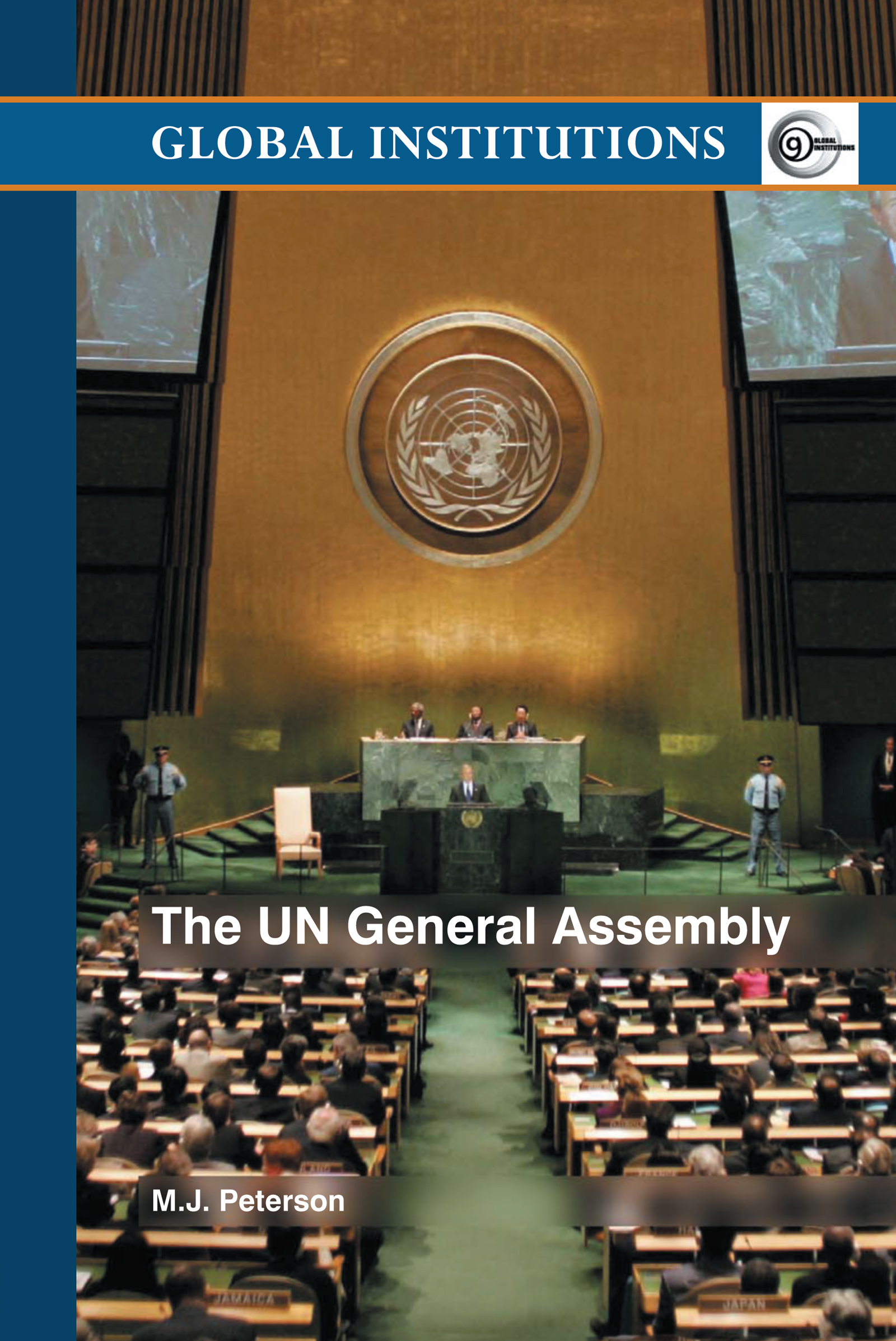
The UN General Assembly The United Nations General Assembly is arguably the most important discussion forum in global politics. This is a concise and accessible introduction to its history, organization and politics. Examining the development of the Assembly as a forum for improving international cooperation, this study details its development of shared norms and goals in the political context of the immediate post-World War II era. The Assembly has had to adapt quickly to the Cold War, the South-North contentions over development, the dissolution of the Soviet bloc and the rise in concern about terrorism. This study also presents a fascinating look ahead to three potential futures: a world of states, a world government, and a world of network governance. To flourish in any of these contexts it shows how the practices of the institution will require considerable change. The common criticisms of the Assembly are also covered in depth, such as that it is just a talking shop; that it is hamstrung by the Security Council and that it benefits the rich at the expense of the poor. This is an ideal book for students of the United Nations, international organizations and global governance. POLITICAL SCIENCE,General

The Politics of Insecurity The act of violence of 9/11 changed the global security agenda, catapulting terrorism to the top of the agenda. Weapons of mass destruction grabbed public interest and controlling the free movement of people became a national security priority. In this volume, Jef Huysmans critically engages with theoretical developments in international relations and security studies to develop a conceptual framework for studying security. He argues that security policies and responses do not appear out of the blue, but are part of a continuous and gradual process, pre-structured by previous developments. He examines this process of securitization and explores how an issue, on the basis of the distribution and administration of fear, becomes a security policy. Huysmans then applies this theory to provide a detailed analysis of migration, asylum and refuge in the European Union. This theoretically sophisticated, yet accessible volume, makes an important contribution to the study of security, migration and European politics. POLITICAL SCIENCE,General

Storming the Gates of Paradise Rebecca Solnit has made a vocation of journeying into difficult territory and reporting back, as an environmentalist, antiglobalization activist, and public intellectual. Storming the Gates of Paradise, an anthology of her essential essays from the past ten years, takes the reader from the Pyrenees to the U.S.--Mexican border, from San Francisco to London, from open sky to the deepest mines, and from the antislavery struggles of two hundred years ago to today’s street protests. The nearly forty essays collected here comprise a unique guidebook to the American landscape after the millennium—not just the deserts, skies, gardens, and wilderness areas that have long made up Solnit’s subject matter, but the social landscape of democracy and repression, of borders, ruins, and protests. She ventures into territories as dark as prison and as sublime as a broad vista, revealing beauty in the harshest landscape and political struggle in the most apparently serene view. Her introduction sets the tone and the book’s overarching themes as she describes Thoreau, leaving the jail cell where he had been confined for refusing to pay war taxes and proceeding directly to his favorite huckleberry patch. In this way she links pleasure to politics, brilliantly demonstrating that the path to paradise has often run through prison. These startling insights on current affairs, politics, culture, and history, always expressed in Solnit’s pellucid and graceful prose, constantly revise our views of the otherwise ordinary and familiar. Illustrated throughout, Storming the Gates of Paradise represents recent developments in Solnit’s thinking and offers the reader a panoramic world view enriched by her characteristically provocative, inspiring, and hopeful observations. POLITICAL SCIENCE,General
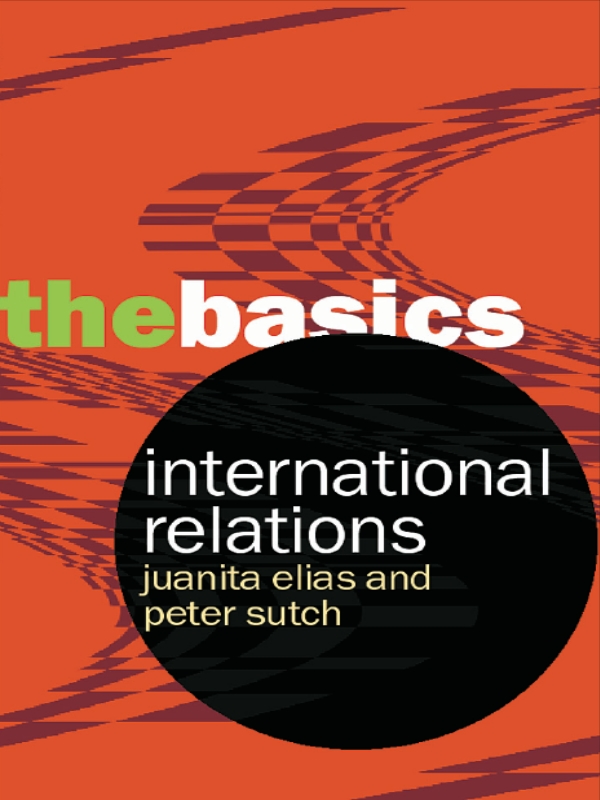
International Relations International Relations is a concise and accessible introduction for students new to international relations and for the general reader. It offers the most up-to-date guide to the major issues and areas of debate and: explains key issues including humanitarian intervention and economic justice features illustrative and familiar case studies from around the world examines topical debates on globalization and terrorism provides an overview of the discipline to situate the new reader at the heart of the study of global politics Covering all the basics and more, this is the ideal book for anyone who wants to understand contemporary international relations. POLITICAL SCIENCE,General

Contemporary Political Theory Contemporary Political Theory: A Reader provides an accessible introduction to the key works of major contemporary political theorists. Key theorists and writers include John Rawls, Robert Nozick, Michael Walzer, Michael Sandel, Susan Okin, Will Kymlicka, Iris Marion Young, Charles Taylor, Nancy Fraser and John Dryzek. POLITICAL SCIENCE,General
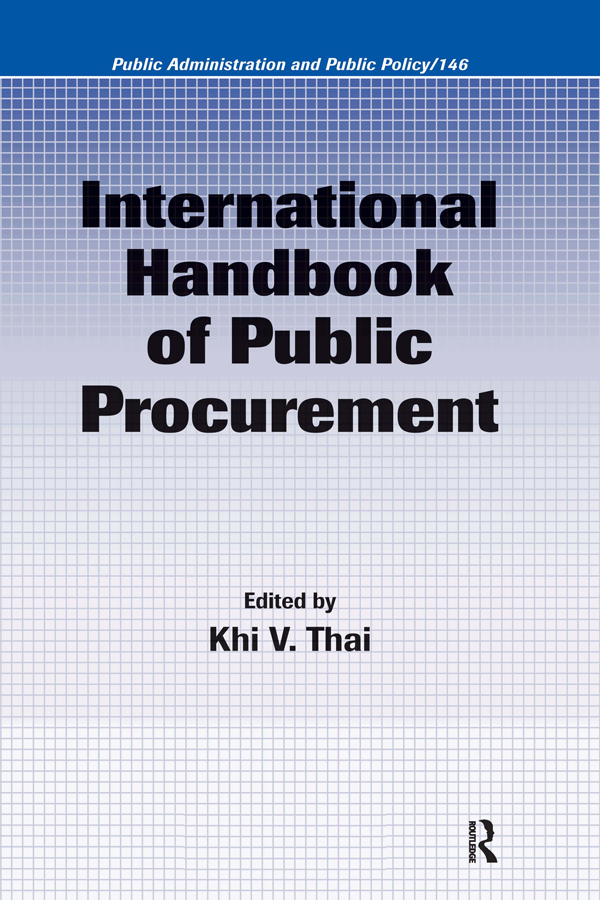
International Handbook of Public Procurement Since the 1990s, government at all levels is under increasing pressure to do more with less. However, despite the U.S. government spending about 15 to 20 percent of its GDP on contracts for goods and services, there is a paucity of reference books for public procurement officials and very few textbooks for courses on the subject. Filling this void, the International Handbook of Public Procurement provides the knowledge necessary to understand how procurement works and how to improve the cost-effectiveness of procurement systems. Taking a multidisciplinary approach, the book focuses on the managerial, economic, political, and legal aspects of this topic. It begins with a conceptual framework and highlights various reforms occurring in certain countries. By examining these improvements, readers are able to apply this knowledge to their own strategies. The next section presents selected cases that illustrate the public procurement process, examining systems in various nations including Germany, China, South Africa, Cambodia, Uganda, and Estonia. The book also discusses the rise of electronic procurement systems (E-procurement) and reviews the benefits of these efficient systems. Other topics presented in this comprehensive volume include practical discussions on contract negotiations, bidding, price strategies and cost analysis, and an insightful chapter on the market’s response to contract award announcements. A virtual encyclopedia from numerous international experts, this book was assembled by Khi V. Thai, Professor at Florida Atlantic University and Editor of the Journal of Public Procurement. Dr. Thai has provided technical assistance in the area of public procurement to governments across the world. Empowering those on all sides of the issue, this volume dispenses advice valuable to government officials and contractors, as well as providing a comprehensive text for public administration students. POLITICAL SCIENCE,General
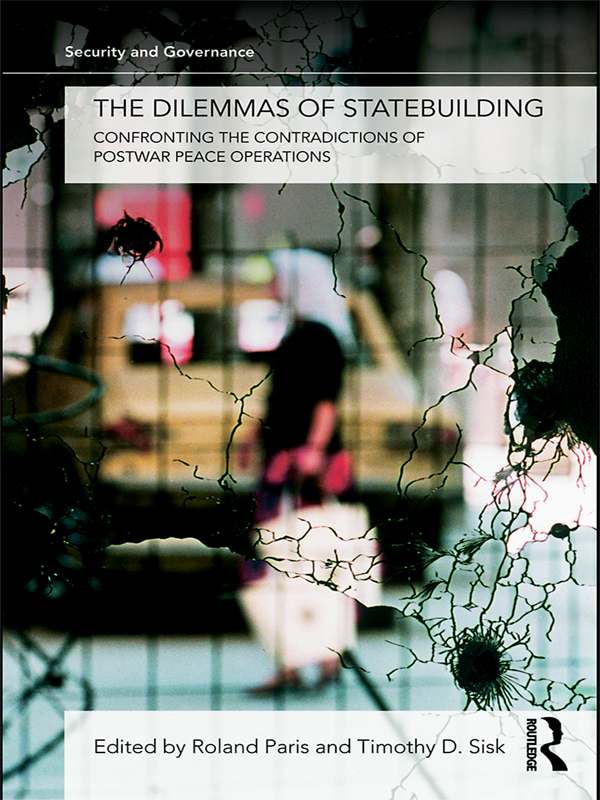
The Dilemmas of Statebuilding This book explores the contradictions that emerge in international statebuilding efforts in war-torn societies. Since the end of the Cold War, more than 20 major peace operations have been deployed to countries emerging from internal conflicts. This book argues that international efforts to construct effective, legitimate governmental structures in these countries are necessary but fraught with contradictions and vexing dilemmas.. Drawing on the latest scholarly research on postwar peace operations, the volume: addresses cutting-edge issues of statebuilding including coordination, local ownership, security, elections, constitution making, and delivery of development aid features contributions by leading and up-and-coming scholars provides empirical case studies including Afghanistan, Cambodia, Croatia, Kosovo, Liberia, Sierra Leone, South Africa, and others presents policy-relevant findings of use to students and policymakers alike The Dilemmas of Statebuilding will be vital reading for students and scholars of international relations and political science. Bringing new insights to security studies, international development, and peace and conflict research, it will also interest a range of policy makers. POLITICAL SCIENCE,General
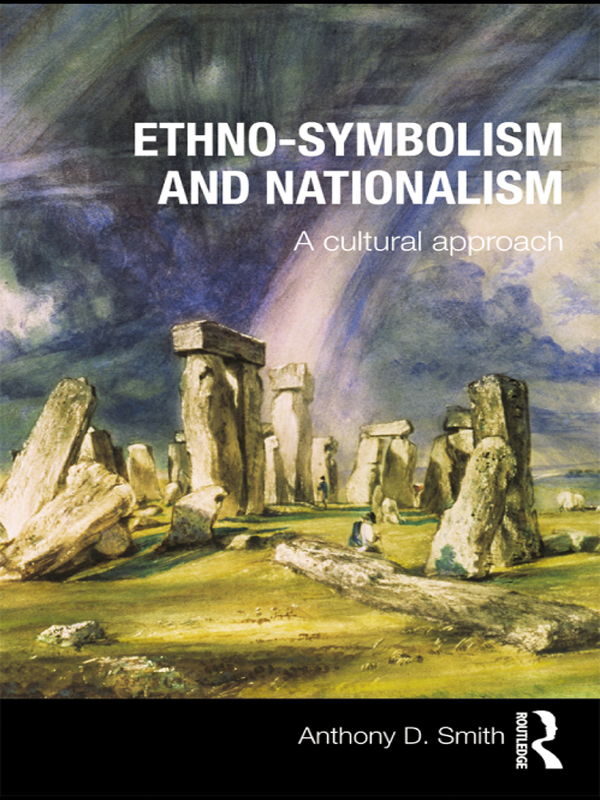
Ethno-symbolism and Nationalism Anthony D. Smith is Emeritus Professor of Nationalism and Ethnicity at the London School of Economics, and is considered one of the founders of the interdisciplinary field of nationalism studies. Anthony Smith has developed an approach to the study of nations and nationalism called ethno-symbolism, which is concerned with the nature of ethnic groups and nations, and the need to consider their symbolic dimensions. This text provides a concise statement of an ethno-symbolic approach to the study of nations and nationalism and at the same time, embodies a general statement of Anthony Smith’s contribution to this approach and its application to the central issues of nations and nationalism. The text: sets out the theoretical background of the emergence of ethno-symbolism in a sustained and systematic argument explains its analysis of the formation of nations, their persistence and change and the role of nationalism demonstrates that an ethno-symbolic approach provides an important supplement and corrective to past and present intellectual orthodoxies in the field and addresses the main theoretical criticisms levelled at an ethno-symbolic approach. Drawing together and developing earlier brief resumes of Anthony Smith’s approach, this book represents a summary of the theoretical aspects of his work in the field since l986. It will be useful to students and to all those who are interested in the issues raised by a study of ethnicity, nations and nationalism. POLITICAL SCIENCE,General
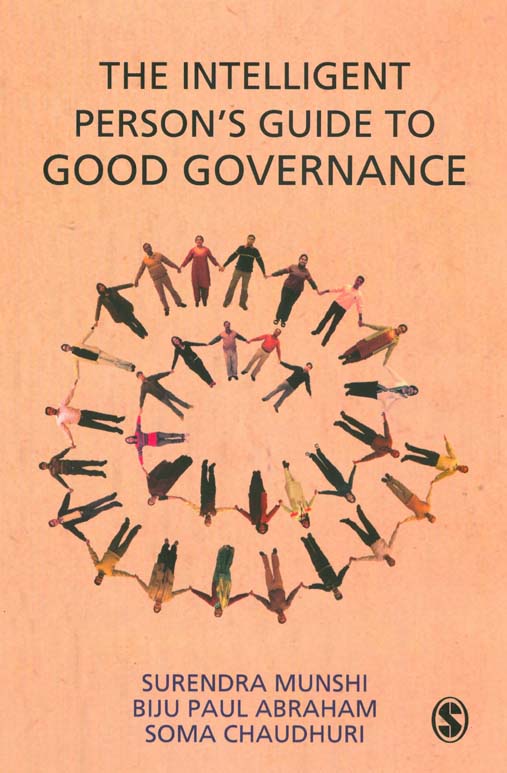
The Intelligent Person's Guide to Good Governance In carrying out a lucid analysis of a fluid concept, The Intelligent Person's Guide to Good Governance offers a 'one-stop' resource for understanding the subject. The central argument of the book that any serious engagement with good governance must go beyond an exclusive reliance on the state or the market and explore different modes of partnerships, including public participation, is relevant and indeed timely in the present crisis. POLITICAL SCIENCE,General

Modern Local Government Modern Local Government is a unique assessment of local government reform from the perspective of both local and central government, which is fully informed an analysis of the role of the European Union. This text provides a systematic review of the reform of local government since the election of New Labour in 1997. POLITICAL SCIENCE,General

Liberty and Tyranny Don’t miss syndicated radio host and author Mark Levin's #1 New York Times acclaimed and longtime bestselling manifesto for the conservative movement. When nationally syndicated radio host Mark R. Levin’s Liberty and Tyranny appeared in the early months of the Obama presidency, Americans responded by making his clarion call for a new era in conservatism a #1 New York Times bestseller for an astounding twelve weeks. As provocative, well-reasoned, robust, and informed as his on-air commentary, with his love of our country and the legacy of our Founding Fathers reflected on every page, Levin’s galvanizing narrative provides a philosophical, historical, and practical framework for revitalizing the conservative vision and ensuring the preservation of American society. In the face of the modern liberal assault on Constitution-based values, an attack that has resulted in a federal government that is a massive, unaccountable conglomerate, the time for reinforcing the intellectual and practical case for conservatism is now. In a series of powerful essays, Levin lays out how conservatives can counter the tyrannical liberal corrosion that has filtered into every timely issue affecting our daily lives, from the economy to health care, global warming to immigration, and more. POLITICAL SCIENCE,General

The Rise and Fall of Communism “A work of considerable delicacy and nuance….Brown has crafted a readable and judicious account of Communist history…that is both controversial and commonsensical.â€â€”Salon.com “Ranging wisely and lucidly across the decades and around the world, this is a splendid book.â€â€”William Taubman, Pulitzer Prize-winning author of Khrushchev: The Man and His Era The Rise and Fall of Communism is the definitive history from the internationally renowned Oxford authority on the subject. Emeritus Professor of Politics at Oxford University, Archie Brown examines the origins of the most important political ideology of the 20th century, its development in different nations, its collapse in the Soviet Union following perestroika, and its current incarnations around the globe. Fans of John Lewis Gaddis, Samuel Huntington, and avid students of history will appreciate the sweep and insight of this epic and astonishing work. POLITICAL SCIENCE,General
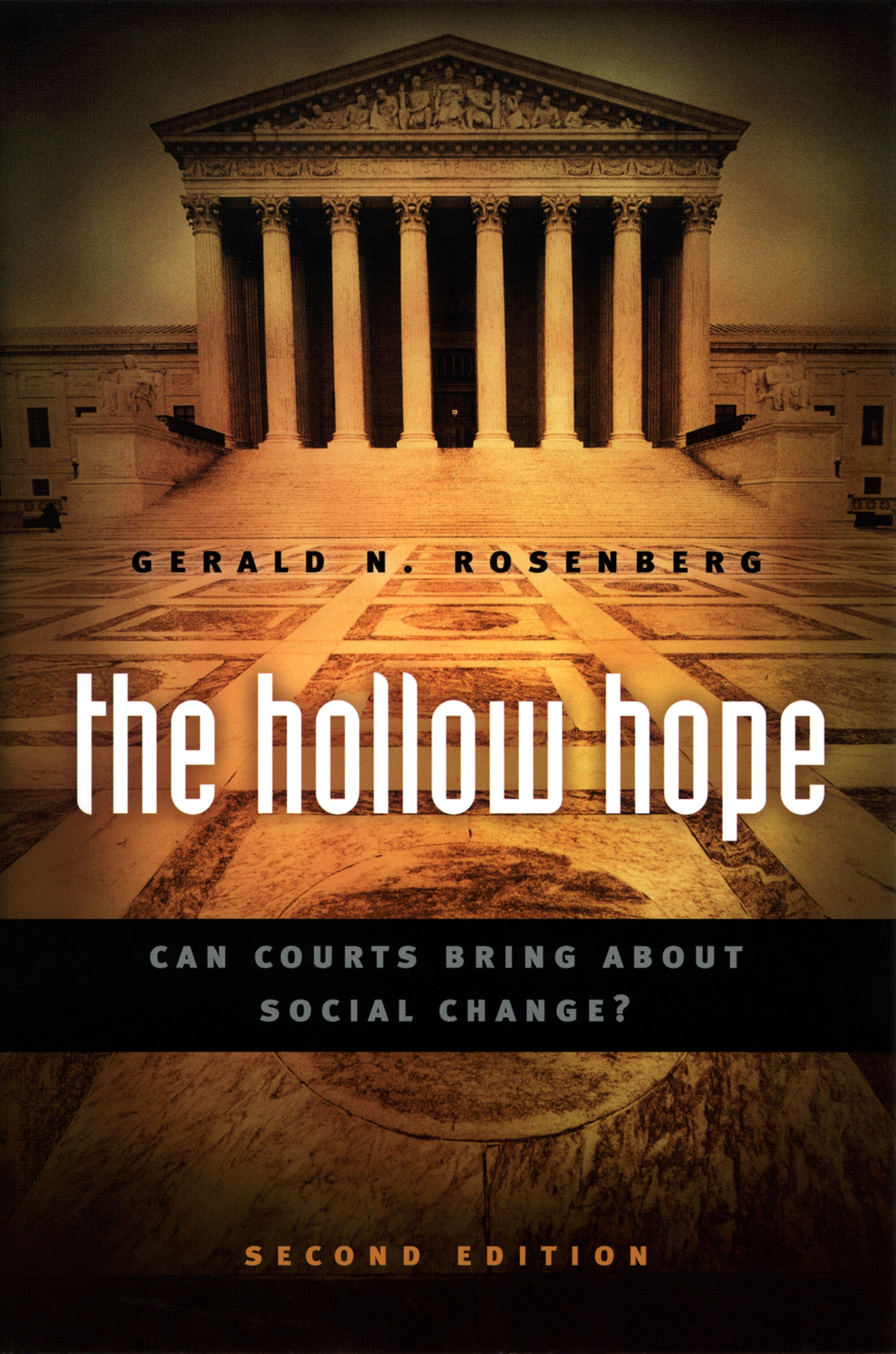
The Hollow Hope In follow-up studies, dozens of reviews, and even a book of essays evaluating his conclusions, Gerald Rosenberg’s critics—not to mention his supporters—have spent nearly two decades debating the arguments he first put forward in The Hollow Hope. With this substantially expanded second edition of his landmark work, Rosenberg himself steps back into the fray, responding to criticism and adding chapters on the same-sex marriage battle that ask anew whether courts can spur political and social reform. Finding that the answer is still a resounding no, Rosenberg reaffirms his powerful contention that it’s nearly impossible to generate significant reforms through litigation. The reason? American courts are ineffective and relatively weak—far from the uniquely powerful sources for change they’re often portrayed as. Rosenberg supports this claim by documenting the direct and secondary effects of key court decisions—particularly Brown v. Board of Education and Roe v. Wade. He reveals, for example, that Congress, the White House, and a determined civil rights movement did far more than Brown to advance desegregation, while pro-choice activists invested too much in Roe at the expense of political mobilization. Further illuminating these cases, as well as the ongoing fight for same-sex marriage rights, Rosenberg also marshals impressive evidence to overturn the common assumption that even unsuccessful litigation can advance a cause by raising its profile. Directly addressing its critics in a new conclusion, The Hollow Hope, Second Edition promises to reignite for a new generation the national debate it sparked seventeen years ago. POLITICAL SCIENCE,General

External Perceptions of the European Union as a Global Actor This book examines how the European Union (EU) is perceived beyond its borders in the US; the Middle East: Israel, Palestinian territories, Lebanon, Iran; Russia; China; India; Brazil and South Africa. The book also analyses the main perceptions of the EU in some key international institutions, including the World Bank; World Trade Organization, United Nations, African Union; and transnational actors, including non-Western media such as Al Jazeera. It seeks to provide a thorough analysis of the implications that these perceptions might have for the global role of the EU. By taking this approach and by providing both conceptual and empirical arguments, the volume provides an innovative perspective on the analysis of the EU as a global actor. It also strengthens a research agenda on the EU external image: an underdeveloped area of investigation in which the editors and the main contributors to this volume have played a pioneering role in the past few years. It will be of strong interest to academics and students of international politics, European studies and development studies. POLITICAL SCIENCE,General
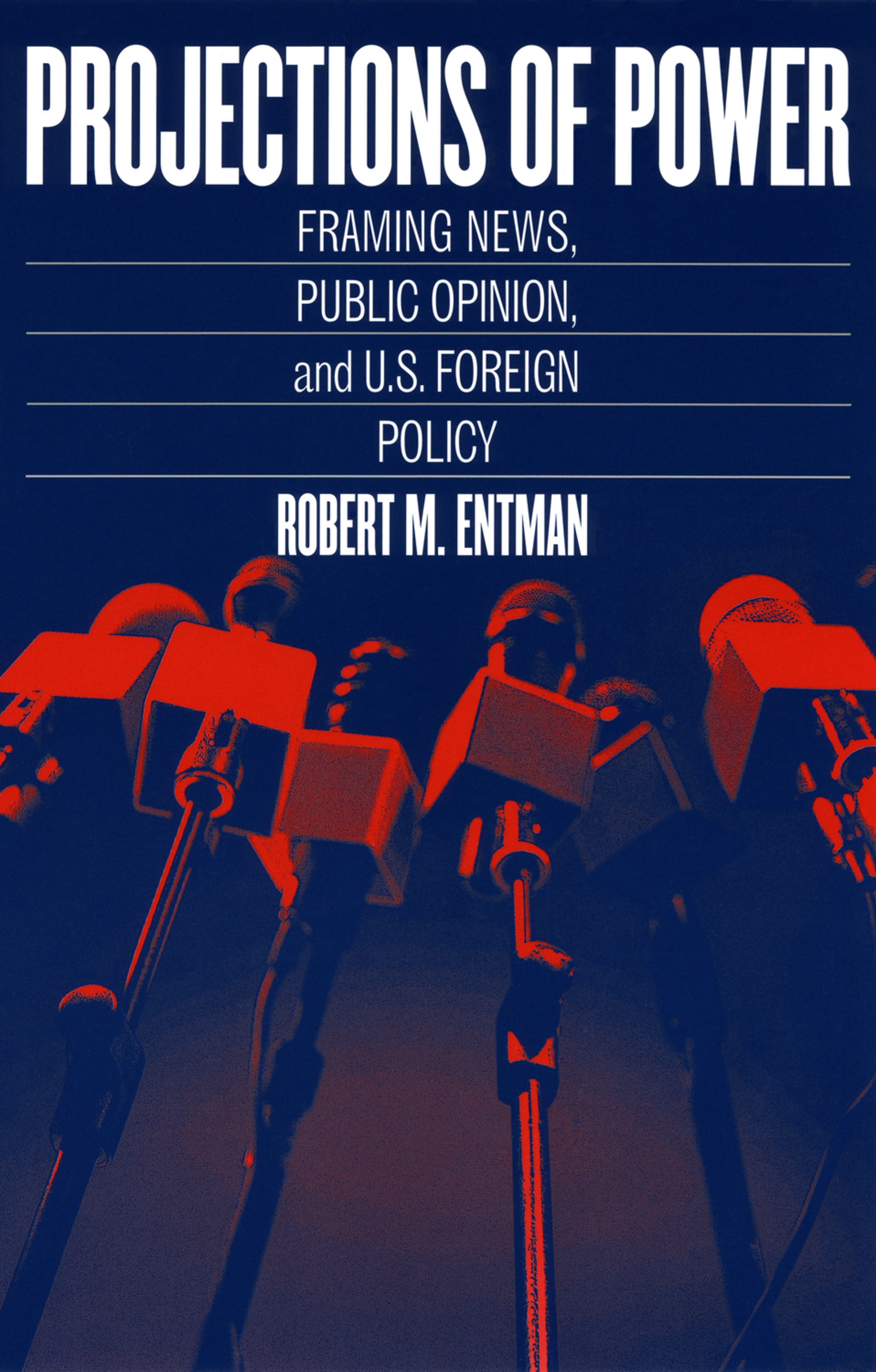
Projections of Power To succeed in foreign policy, U.S. presidents have to sell their versions or framings of political events to the news media and to the public. But since the end of the Cold War, journalists have increasingly resisted presidential views, even offering their own spin on events. What, then, determines whether the media will accept or reject the White House perspective? And what consequences does this new media environment have for policymaking and public opinion? To answer these questions, Robert M. Entman develops a powerful new model of how media framing works—a model that allows him to explain why the media cheered American victories over small-time dictators in Grenada and Panama but barely noticed the success of far more difficult missions in Haiti and Kosovo. Discussing the practical implications of his model, Entman also suggests ways to more effectively encourage the exchange of ideas between the government and the media and between the media and the public. His book will be an essential guide for political scientists, students of the media, and anyone interested in the increasingly influential role of the media in foreign policy. POLITICAL SCIENCE,General
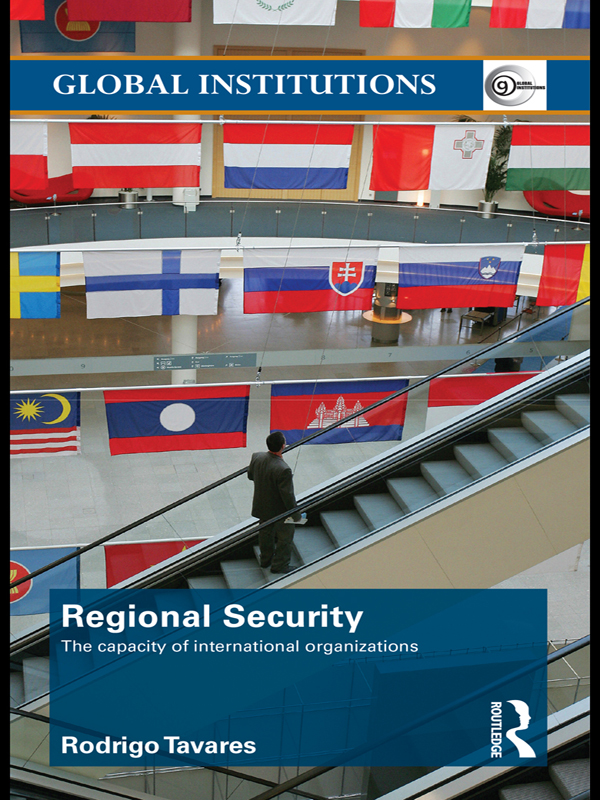
Regional Security Regional organizations are an inescapable feature of global politics. Virtually all countries in the world are members of at least one regional or other intergovernmental organization. The involvement of international organizations in the realm of regional peace and security, and their cooperation in this domain with the United Nations, has reached an unprecedented level. Regional organizations have traditionally been formed around economic, political, or environmental objectives, however, over the last decades these organizations have gradually penetrated into the security sphere and developed their capacities in conflict prevention, peacekeeping, or post-war reconstruction. In Europe, Africa, Asia, or the Americas, regional and other intergovernmental organizations have been concurrently empowered by the UN and their own member states to maintain peace and security. Despite suffering from important discrepancies in both their mandates and capacities, regional organizations have become indisputable actors that play a role from the outbreak of a crisis to the reconstruction efforts in the aftermath of a conflict Presenting the most up-to-date critical and comparative analysis of the major regional security institutions, assessing a wide range of regional organizations and providing an accessible and comprehensive guide to 11 key organizations, this book is the first systematic study of the capacities of the most recognized intergovernmental organizations with a security mandate. Regional Security is essential reading for all students of international organizations, peace and security studies and global governance. POLITICAL SCIENCE,General
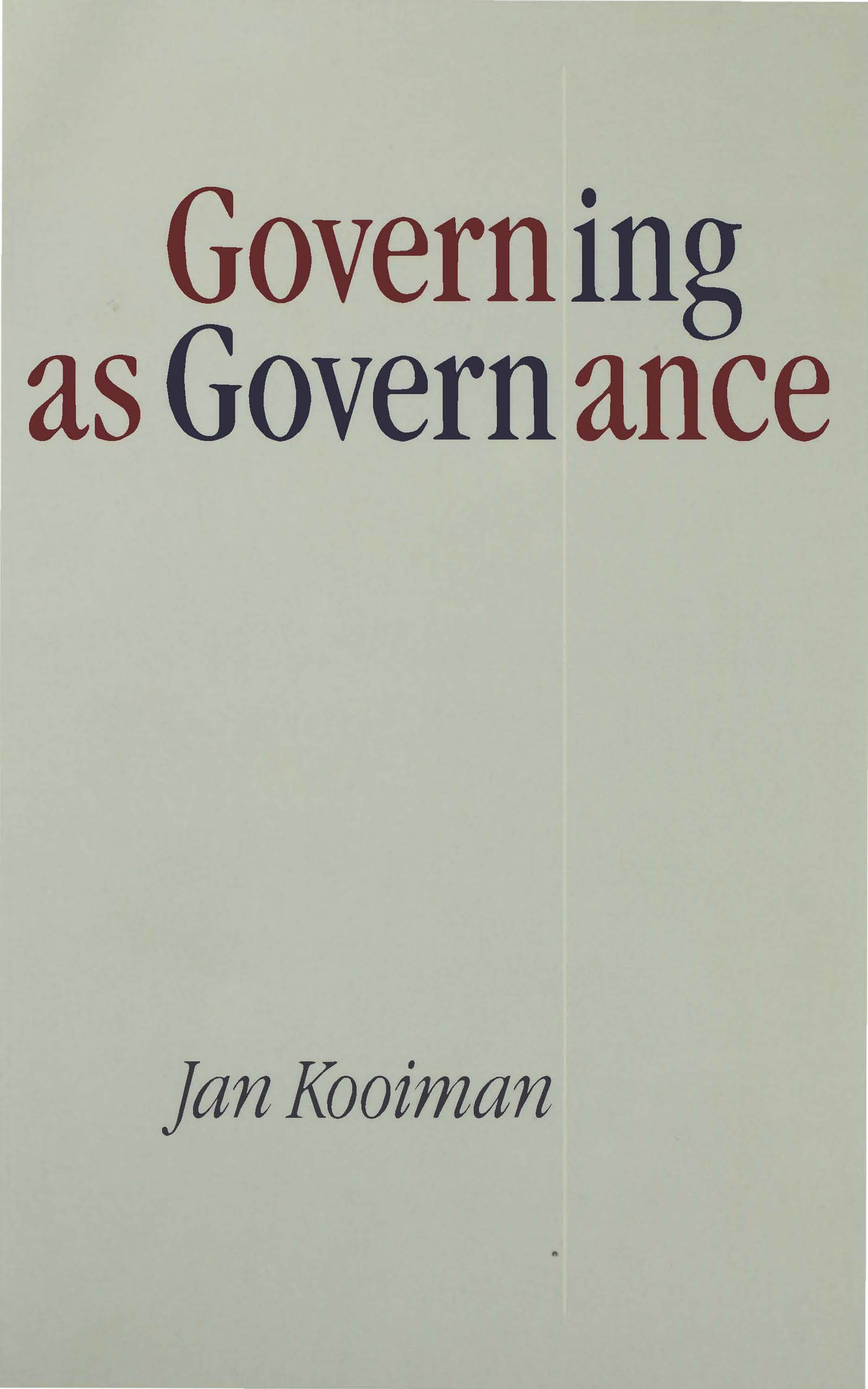
Governing as Governance The concept of `governance' has become a central catchword across the social and political sciences. In Governing as Governance, Jan Kooiman revisits and develops his seminal work in the field to map and demonstrate the utility of a sociopolitical perspective to our understanding of contemporary forms of governing, governance and governability. POLITICAL SCIENCE,General
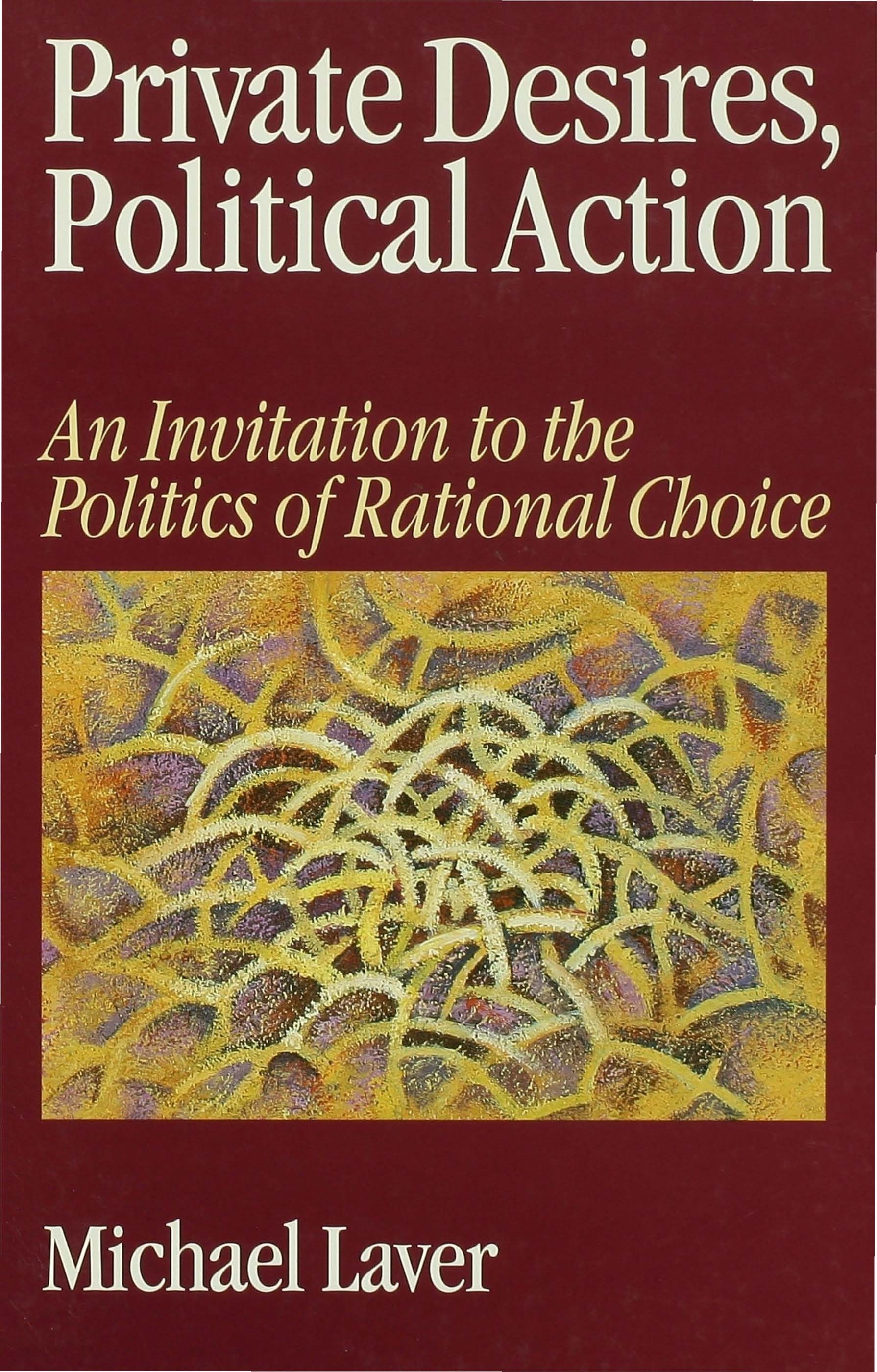
Private Desires, Political Action Private Desires, Political Action is an accessible overview of one of the most important approaches to the study of politics in the modern world - rational choice theory. Michael Laver does not set out to review this entire field, but rather to discuss how we might use rational choice theory to analyze the political competition that affects almost every aspect of our lives. The broad-ranging scope of the book introduces the theory at many levels of analysis, including: the private desires of individuals; the social context of how people fulfil their desires; and the problems of collective action. The discussion of these problems extends into the arena of politics, where the activities of `political entrepreneurs' or POLITICAL SCIENCE,General
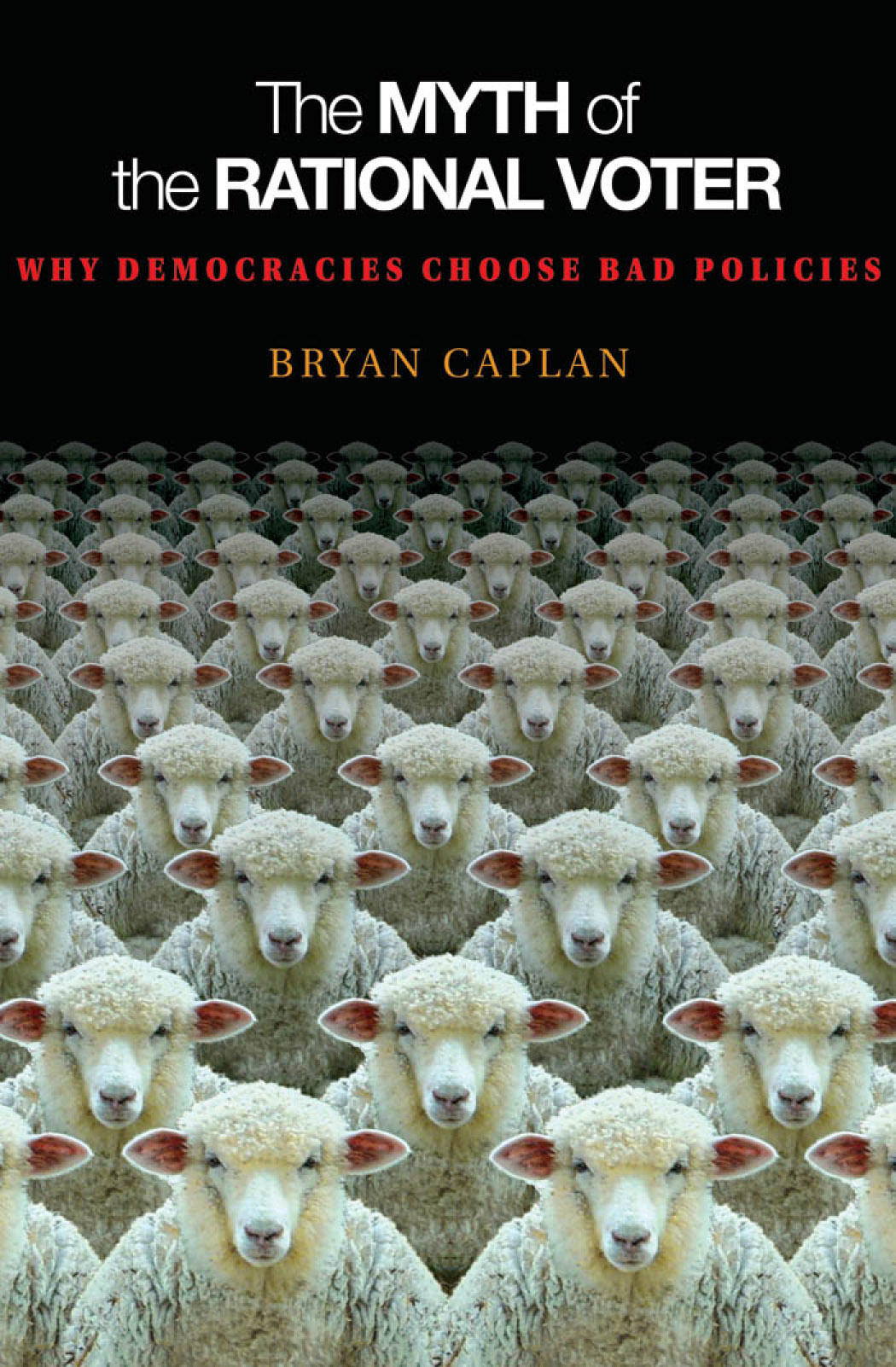
The Myth of the Rational Voter The greatest obstacle to sound economic policy is not entrenched special interests or rampant lobbying, but the popular misconceptions, irrational beliefs, and personal biases held by ordinary voters. This is economist Bryan Caplan's sobering assessment in this provocative and eye-opening book. Caplan argues that voters continually elect politicians who either share their biases or else pretend to, resulting in bad policies winning again and again by popular demand. Boldly calling into question our most basic assumptions about American politics, Caplan contends that democracy fails precisely because it does what voters want. Through an analysis of Americans' voting behavior and opinions on a range of economic issues, he makes the convincing case that noneconomists suffer from four prevailing biases: they underestimate the wisdom of the market mechanism, distrust foreigners, undervalue the benefits of conserving labor, and pessimistically believe the economy is going from bad to worse. Caplan lays out several bold ways to make democratic government work better--for example, urging economic educators to focus on correcting popular misconceptions and recommending that democracies do less and let markets take up the slack. The Myth of the Rational Voter takes an unflinching look at how people who vote under the influence of false beliefs ultimately end up with government that delivers lousy results. With the upcoming presidential election season drawing nearer, this thought-provoking book is sure to spark a long-overdue reappraisal of our elective system. POLITICAL SCIENCE,General

Hardball How politics is played by one who knows the game... Chris Matthews has spent a quarter century on the playing field of American politics—from right-hand man of Speaker of the House Tip O'Neill to host of NBC's highest rated cable talk show Hardball. In this revised and updated edition of his political classic, he offers fascinating new stories of raw ambition, brutal rivalry, and exquisite seduction and reveals the inside rules that govern the game of power. POLITICAL SCIENCE,General
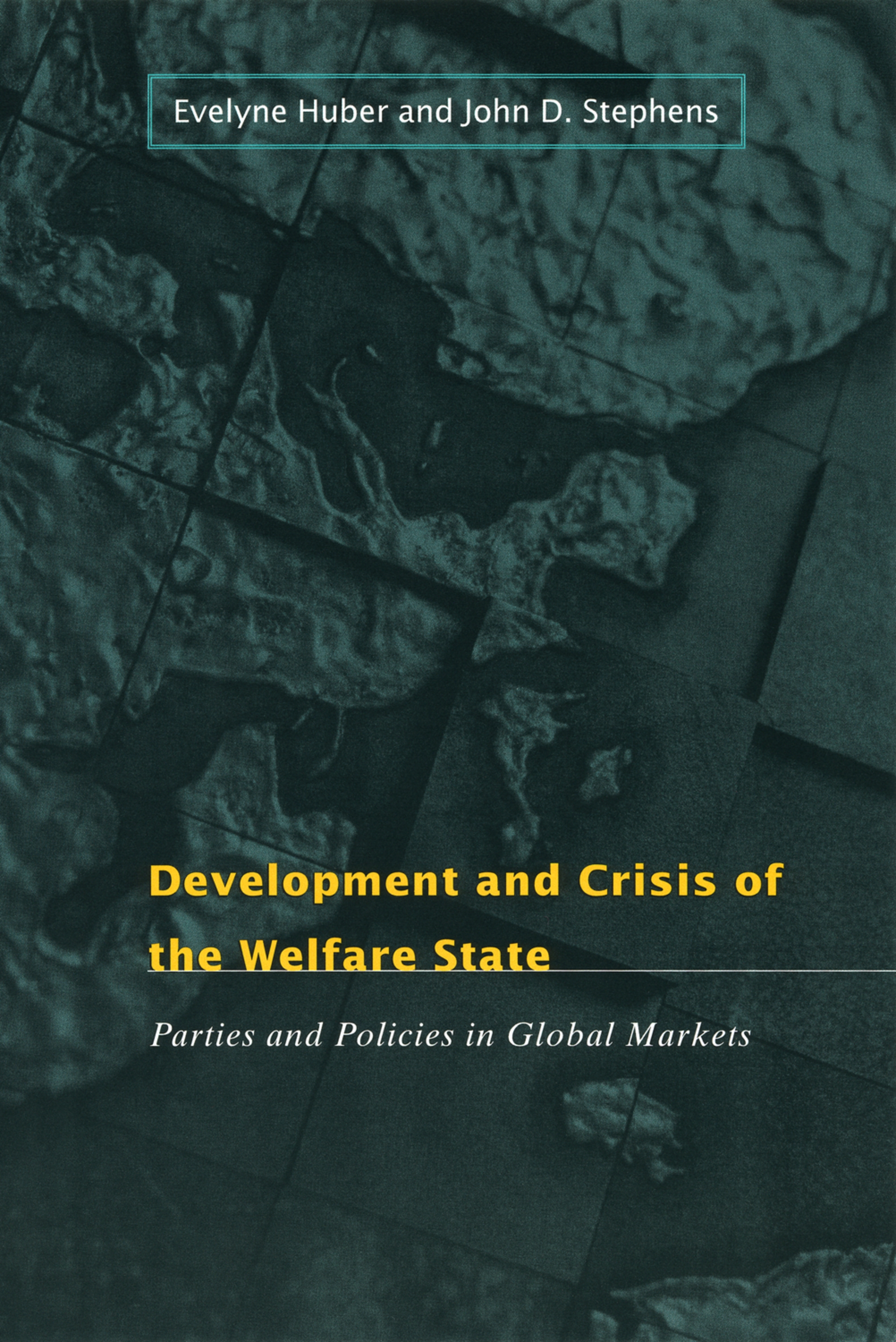
Development and Crisis of the Welfare State Evelyne Huber and John D. Stephens offer the most systematic examination to date of the origins, character, effects, and prospects of generous welfare states in advanced industrial democracies in the post—World War II era. They demonstrate that prolonged government by different parties results in markedly different welfare states, with strong differences in levels of poverty and inequality. Combining quantitative studies with historical qualitative research, the authors look closely at nine countries that achieved high degrees of social protection through different types of welfare regimes: social democratic states, Christian democratic states, and "wage earner" states. In their analysis, the authors emphasize the distribution of influence between political parties and labor movements, and also focus on the underestimated importance of gender as a basis for mobilization. Building on their previous research, Huber and Stephens show how high wages and generous welfare states are still possible in an age of globalization and trade competition. POLITICAL SCIENCE,General

There Goes the Hood In this revealing book, Lance Freeman sets out to answer a seemingly simple question: how does gentrification actually affect residents of neighborhoods in transition? To find out, Freeman does what no scholar before him has done. He interviews the indigenous residents of two predominantly black neighborhoods that are in the process of gentrification: Harlem and Clinton Hill, Brooklyn. By listening closely to what people tell him, he creates a more nuanced picture of the impacts of gentrification on the perceptions, attitudes and behaviors of the people who stay in their neighborhoods. Freeman describes the theoretical and planning/policy implications of his findings, both for New York City and for any gentrifying urban area. There Goes the 'Hood provides a more complete, and complicated, understanding of the gentrification process, highlighting the reactions of long-term residents. It suggests new ways of limiting gentrification's negative effects and of creating more positive experiences for newcomers and natives alike. POLITICAL SCIENCE,General

The Politics of Rural Reform in China Based on a treasure trove of information collected through fieldwork interviews and painstaking documentary research through the Chinese and Western language presses, this book analyzes one of the most important reforms implemented in China over the past decade – the rural tax and fee reform, also known as the "Third Revolution in the Countryside". The aim of the tax was to improve social stability in rural China, which has become increasingly shaken by peasant protests, many of them large-scale and violent. By examining the gap between the intentions of the reform and the eventual outcomes, Göbel provides new insights into the nature of intergovernmental relations in China and highlights the ways in which the relationship between the state and the rural populace has fundamentally changed forever. The Politics of Rural Reform in China will appeal to students and scholars of Chinese politics, governance and development studies. POLITICAL SCIENCE,General
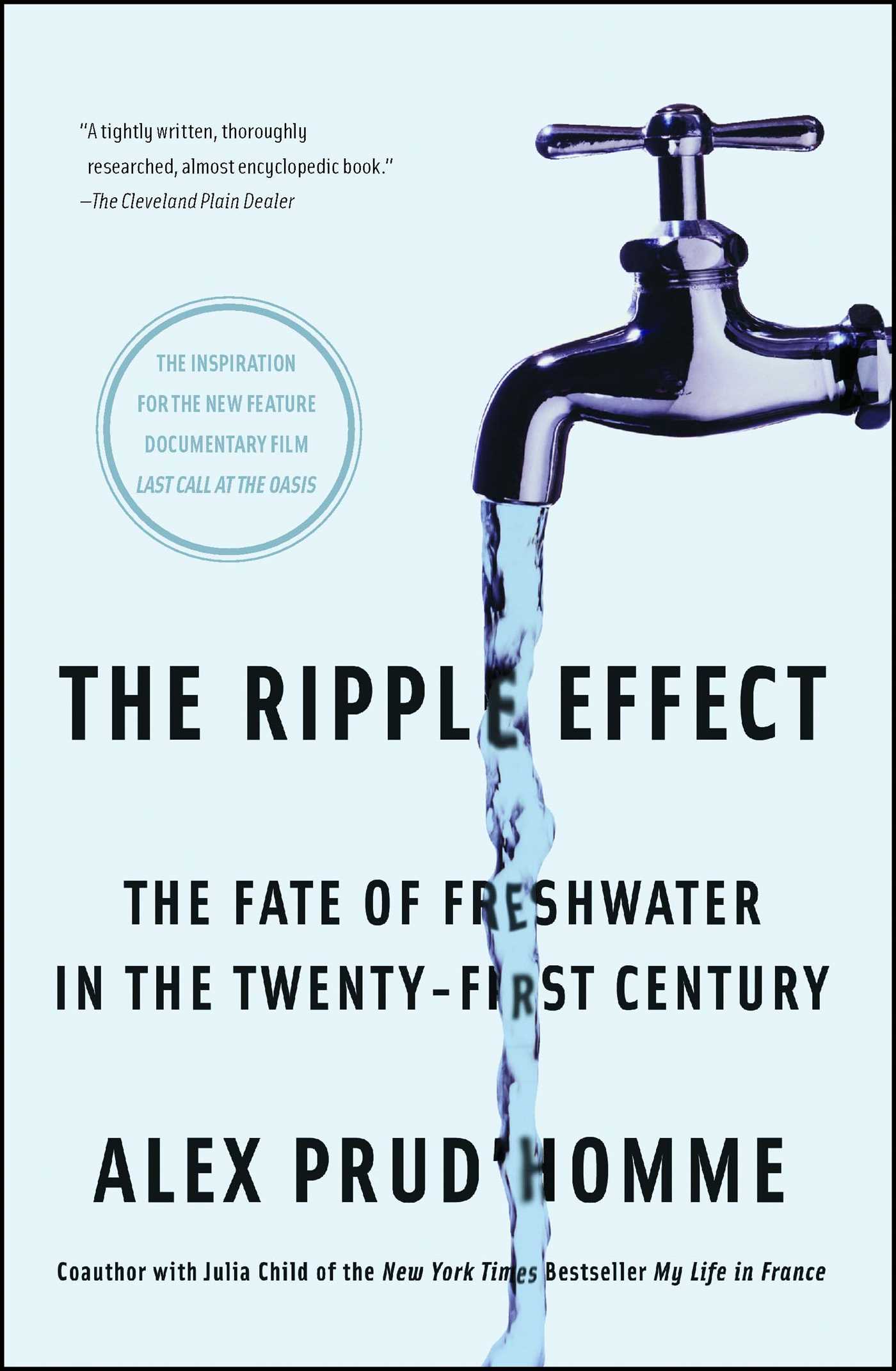
The Ripple Effect AS ALEX PRUD’HOMME and his great-aunt Julia Child were completing their collaboration on her memoir, My Life in France, they began to talk about the French obsession with bottled water, which had finally spread to America. From this spark of interest, Prud’homme began what would become an ambitious quest to understand the evolving story of freshwater. What he found was shocking: as the climate warms and world population grows, demand for water has surged, but supplies of freshwater are static or dropping, and new threats to water quality appear every day. The Ripple Effect is Prud’homme’s vivid and engaging inquiry into the fate of freshwater in the twenty-first century. The questions he sought to answer were urgent: Will there be enough water to satisfy demand? What are the threats to its quality? What is the state of our water infrastructure—both the pipes that bring us freshwater and the levees that keep it out? How secure is our water supply from natural disasters and terrorist attacks? Can we create new sources for our water supply through scientific innovation? Is water a right like air or a commodity like oil—and who should control the tap? Will the wars of the twenty-first century be fought over water? Like Daniel Yergin’s classic The Prize: The Epic Quest for Oil, Money & Power, Prud’homme’s The Ripple Effect is a masterwork of investigation and dramatic narrative. With striking instincts for a revelatory story, Prud’homme introduces readers to an array of colorful, obsessive, brilliant—and sometimes shadowy—characters through whom these issues come alive. Prud’homme traversed the country, and he takes readers into the heart of the daily dramas that will determine the future of this essential resource—from the alleged murder of a water scientist in a New Jersey purification plant, to the epic confrontation between salmon fishermen and copper miners in Alaska, to the poisoning of Wisconsin wells, to the epidemic of intersex fish in the Chesapeake Bay, to the wars over fracking for natural gas. Michael Pollan has changed the way we think about the food we eat; Alex Prud’homme will change the way we think about the water we drink. Informative and provocative, The Ripple Effect is a major achievement. POLITICAL SCIENCE,General
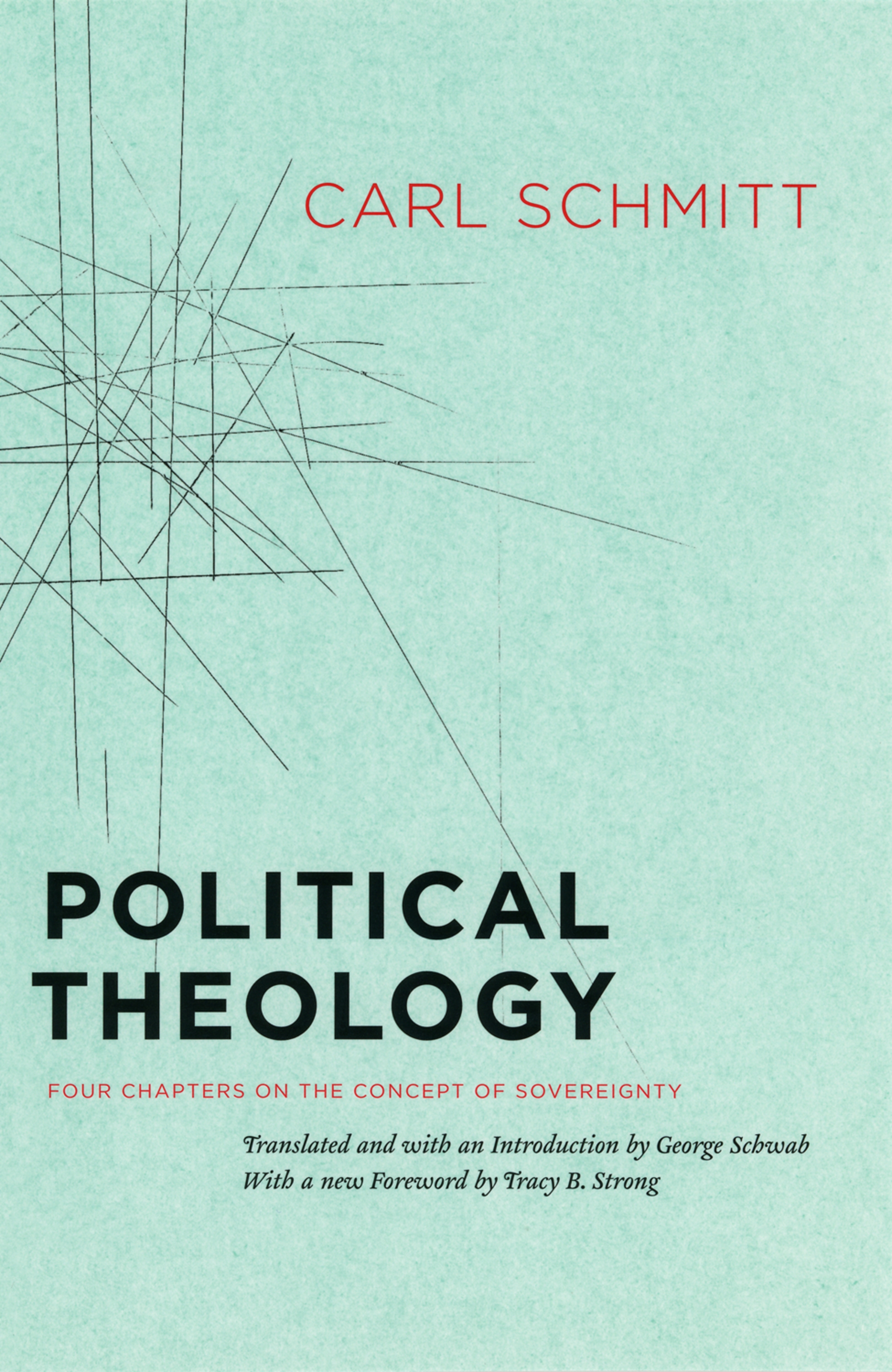
Political Theology Written in the intense political and intellectual tumult of the early years of the Weimar Republic, Political Theology develops the distinctive theory of sovereignty that made Carl Schmitt one of the most significant and controversial political theorists of the twentieth century. Focusing on the relationships among political leadership, the norms of the legal order, and the state of political emergency, Schmitt argues in Political Theology that legal order ultimately rests upon the decisions of the sovereign. According to Schmitt, only the sovereign can meet the needs of an "exceptional" time and transcend legal order so that order can then be reestablished. Convinced that the state is governed by the ever-present possibility of conflict, Schmitt theorizes that the state exists only to maintain its integrity in order to ensure order and stability. Suggesting that all concepts of modern political thought are secularized theological concepts, Schmitt concludes Political Theology with a critique of liberalism and its attempt to depoliticize political thought by avoiding fundamental political decisions. POLITICAL SCIENCE,General

Fifty Key Thinkers on the Holocaust and Genocide This unique volume critically discusses the works of fifty of the most influential scholars involved in the study of the Holocaust and genocide. Studying each scholar’s background and influences, the authors examine the ways in which their major works have been received by critics and supporters, and analyse each thinker’s contributions to the field. Key figures discussed range from historians and philosophers, to theologians, anthropologists, art historians and sociologists, including: Hannah Arendt Christopher Browning Primo Levi Raphael Lemkin Jacques Sémelin Saul Friedländer Samantha Power Hans Mommsen Emil Fackenheim Helen Fein Adam Jones Ben Kiernan. A thoughtful collection of groundbreaking thinkers, this book is an ideal resource for academics, students, and all those interested in both the emerging and rapidly evolving field of Genocide Studies and the established field of Holocaust Studies. POLITICAL SCIENCE,General
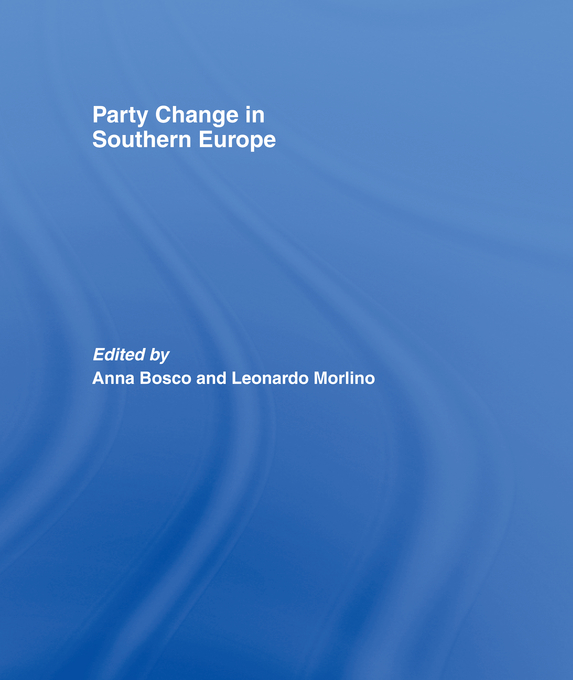
Party Change in Southern Europe It has been argued that political parties are weakening. In Southern Europe, however, political parties have shown remarkable pragmatism. Not only have they played a crucial role in the installation and consolidation of democracy, mostly in the 1970s and 1980s, but they have also adapted to the aftermaths of severe political crises during the 1990s POLITICAL SCIENCE,General
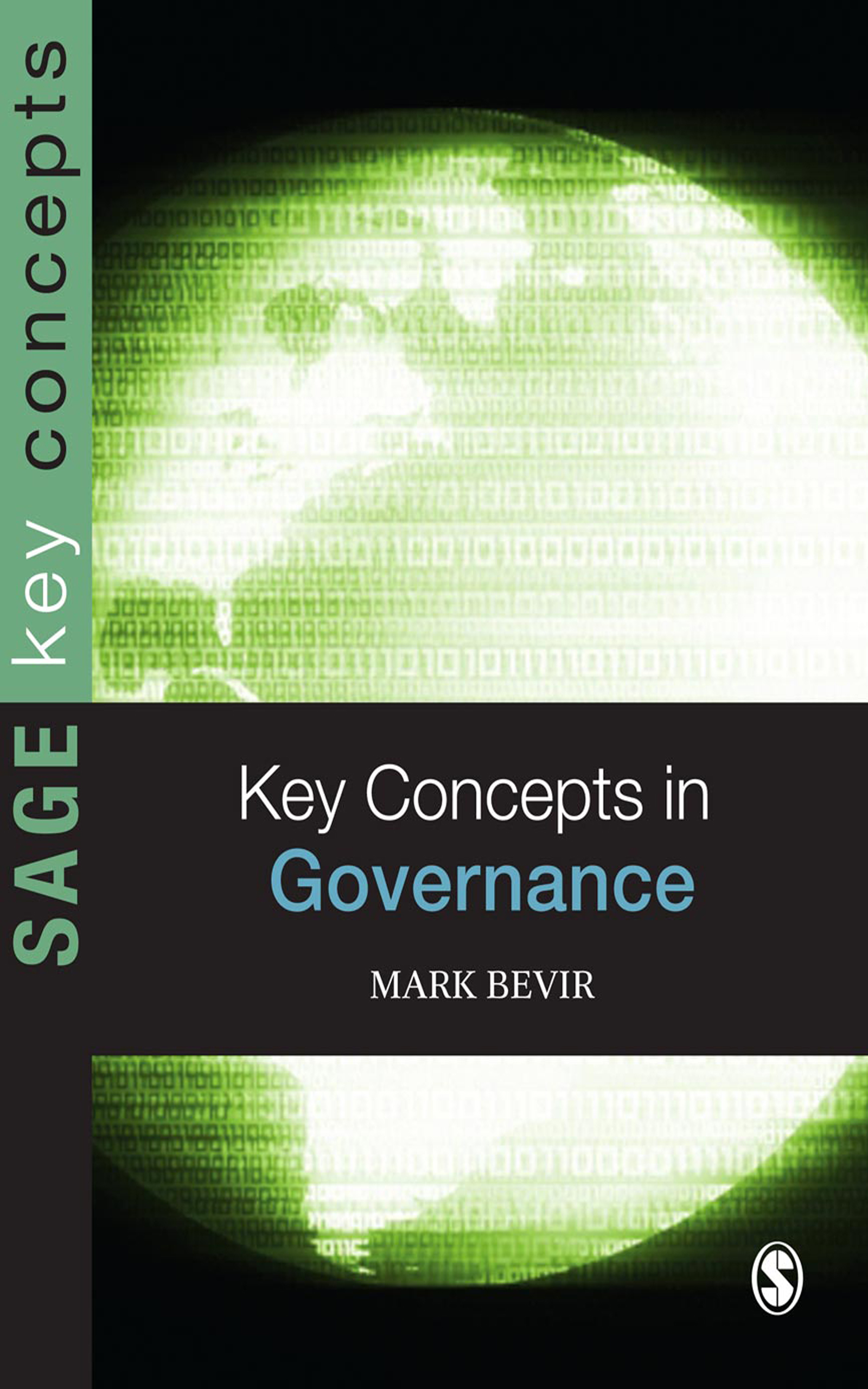
Key Concepts in Governance Clear, student-friendly introduction to the technical concepts and policies of contemporay governance. POLITICAL SCIENCE,General

Secret Affairs The updated edition of Secret Affairs covers the momentous events of the past year in the Middle East. It reveals the unreported attempts by Britain to cultivate relations with the Muslim Brotherhood in Egypt after the fall of Mubarak, the military intervention on the side of Libyan rebel forces which include pro-al-Qaeda elements, and the ongoing reliance on the region's ultimate fundamentalist state, Saudi Arabia, to safeguard its interest in the Middle East. In this ground-breaking book, Mark Curtis reveals the covert history of British collusion with radical Islamic and terrorist groups. Secret Affairs shows how governments since the 1940s have connived with militant forces to control oil resources and overthrow governments. The story of how Britain has helped nurture the rise of global terrorism has never been told. POLITICAL SCIENCE,General
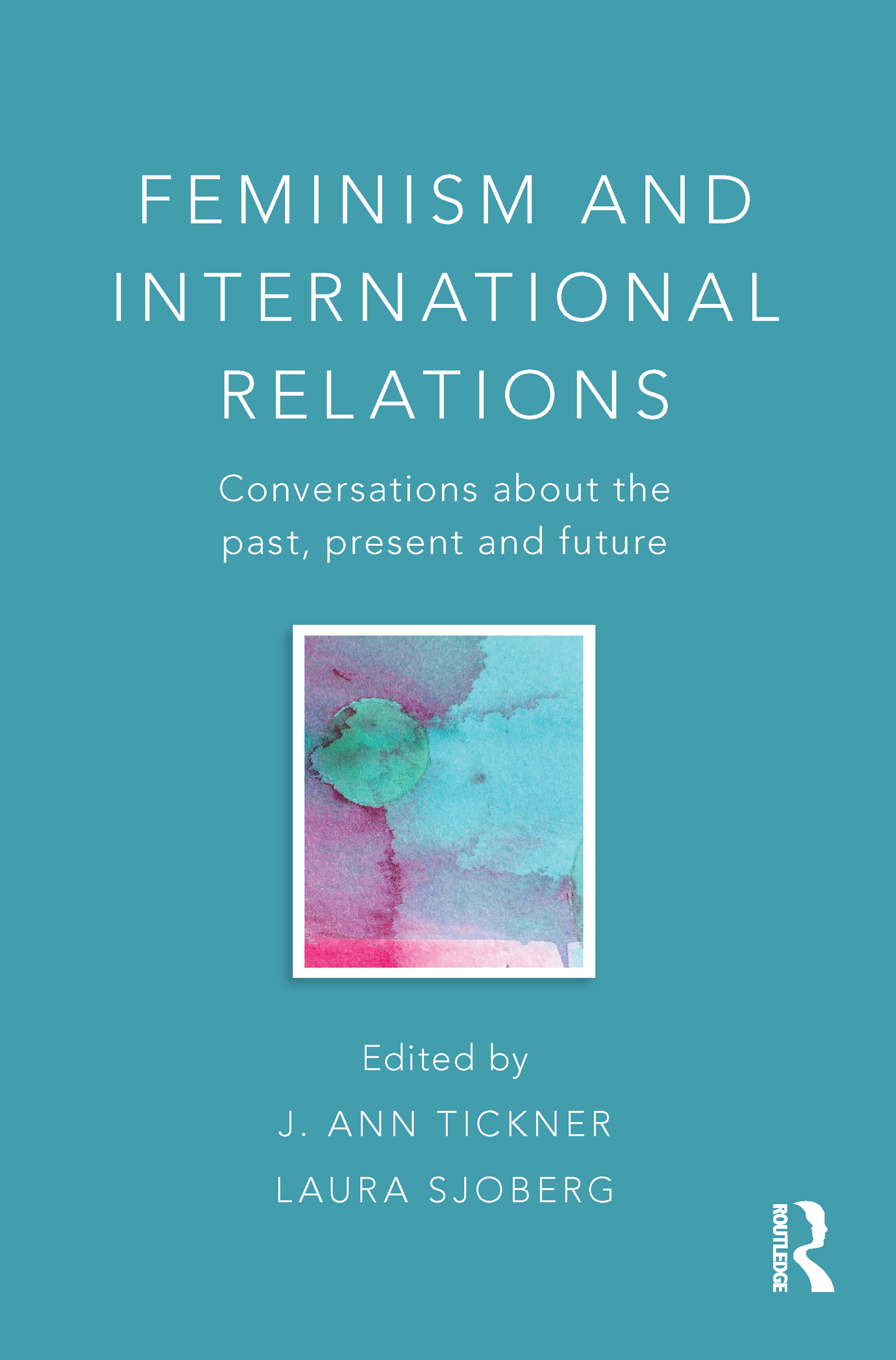
Feminism and International Relations Feminist International Relations scholarship in the United States recently celebrated its 20th anniversary. Over those years, feminist researchers have made substantial progress concerning the question of how gender matters in global politics, global economics, and global culture. The progress has been noted both in the academic field of international relations and, increasingly, in the policy world. Celebrating these achievements, this book constructs conversations about the history, present state of, and future of feminist International Relations as a field across subfields of IR, continents, and generations of scholars. Providing an overview and assessment of what it means to "gender" IR in the 21st century, the volume has a unique format: it features a series of intellectual conversations, presenting cutting-edge research in the field, with provocative comments from senior scholars. It examines issues including global governance, the United Nations, war, peace, security, science, beauty, and human rights and addresses key questions including: What does viewing the diverse problems of global politics through gendered lenses look like in the 21st Century? How do feminisms accommodate differences in culture, race, and religion? How do feminist theoretical and policy analyses fit together? These conversations about feminist IR are accessible to non-specialist audiences and will be of interest to students and scholars of Gender Studies, Feminist Politics and International Relations. POLITICAL SCIENCE,General
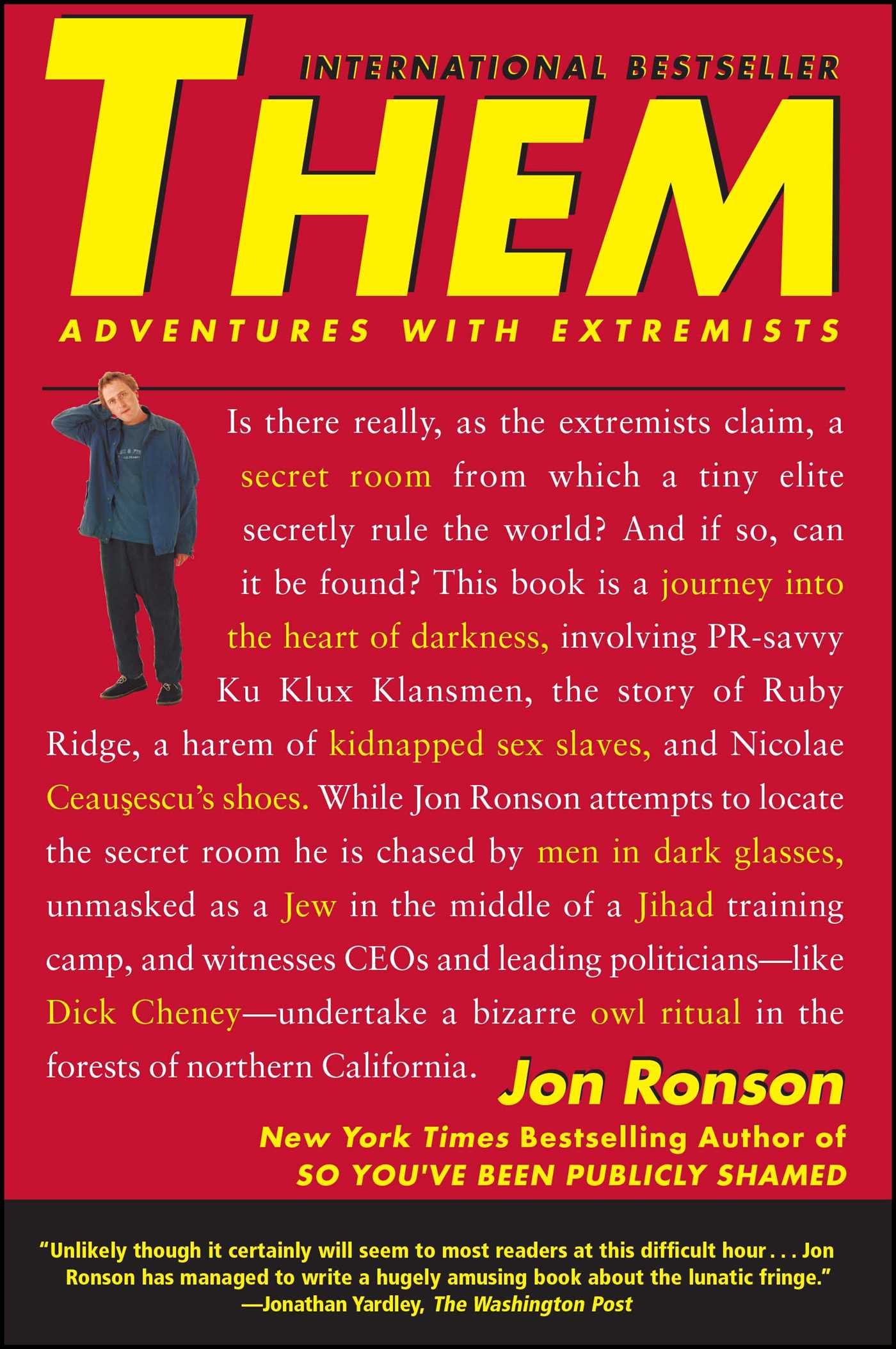
Them A wide variety of extremist groups -- Islamic fundamentalists, neo-Nazis -- share the oddly similar belief that a tiny shadowy elite rule the world from a secret room. In Them, journalist Jon Ronson has joined the extremists to track down the fabled secret room. As a journalist and a Jew, Ronson was often considered one of "Them" but he had no idea if their meetings actually took place. Was he just not invited? Them takes us across three continents and into the secret room. Along the way he meets Omar Bakri Mohammed, considered one of the most dangerous men in Great Britain, PR-savvy Ku Klux Klan Grand Wizard Thom Robb, and the survivors of Ruby Ridge. He is chased by men in dark glasses and unmasked as a Jew in the middle of a Jihad training camp. In the forests of northern California he even witnesses CEOs and leading politicians -- like Dick Cheney and George Bush -- undertake a bizarre owl ritual. Ronson's investigations, by turns creepy and comical, reveal some alarming things about the looking-glass world of "us" and "them." Them is a deep and fascinating look at the lives and minds of extremists. Are the extremists onto something? Or is Jon Ronson becoming one of them? POLITICAL SCIENCE,General

The Disability Rights Movement In this updated edition, Doris Zames Fleischer and Frieda Zames expand their encyclopedic history of the struggle for disability rights in the United States, to include the past ten years of disability rights activism.The book includes a new chapter on the evolving impact of the Americans with Disabilities Act, the continuing struggle for cross-disability civil and human rights, and the changing perceptions of disability. The authors provide a probing analysis of such topics as deinstitutionalization, housing, health care, assisted suicide, employment, education, new technologies, disabled veterans, and disability culture. Based on interviews with over one hundred activists, The Disability Rights Movement tells a complex and compelling story of an ongoing movement that seeks to create an equitable and diverse society, inclusive of people with disabilities. POLITICAL SCIENCE,General
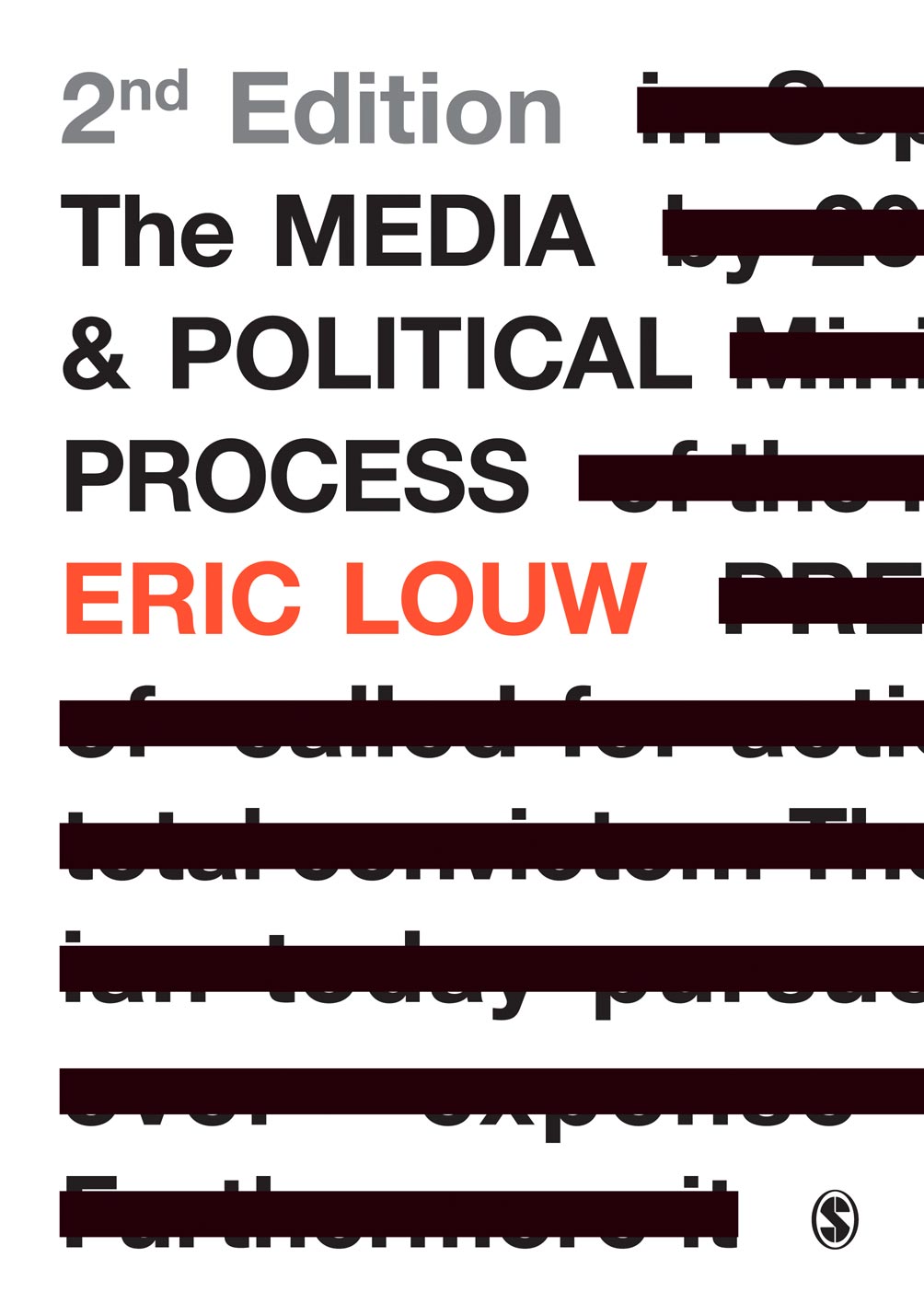
The Media and Political Process Lively, approachable, critical and fully updated edition of Eric Louw's assessment of media activity and political communication in liberal democracies. POLITICAL SCIENCE,General
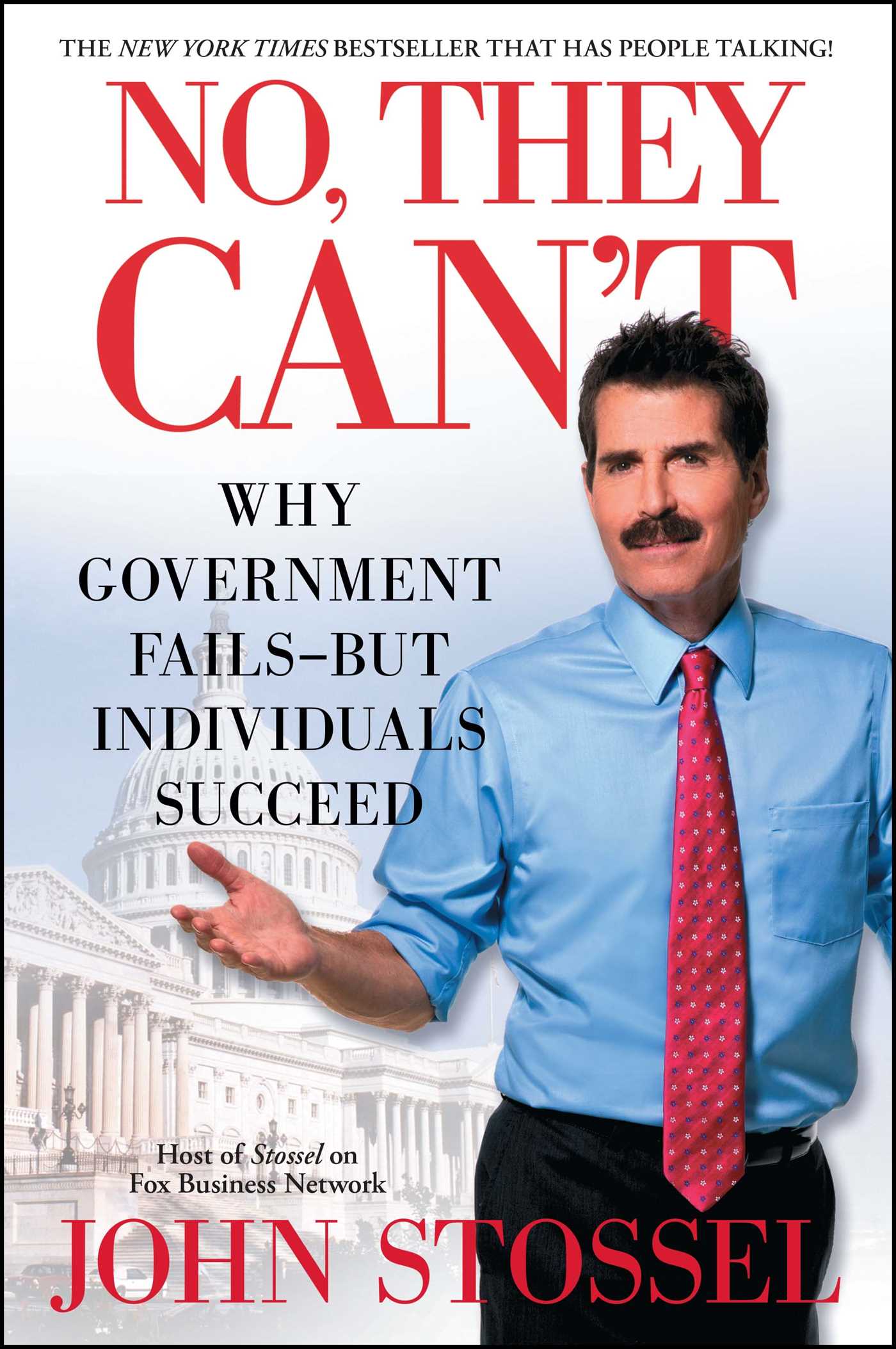
No, They Can't The government is not a neutral arbiter of truth. It never has been. It never will be. Doubt everything. John Stossel does. A self-described skeptic, he has dismantled society’s sacred cows with unerring common sense. Now he debunks the most sacred of them all: our intuition and belief that government can solve our problems. In No, They Can’t, the New York Times bestselling author and Fox News commentator insists that we discard that idea of the “perfect†government—left or right—and retrain our brain to look only at the facts, to rethink our lives as independent individuals—and fast. With characteristic tenacity, John Stossel outlines and exposes the fallacies and facts of the most pressing issues of today’s social and political climate—and shows how our intuitions about them are, frankly, wrong: • the unreliable marriage between big business, the media, and unions • the myth of tax breaks and the ignorance of their advocates • why “central planners†never create more jobs and how government never really will • why free trade works—without government Interference • federal regulations and the trouble they create for consumers • the harm caused to the disabled by government protection of the disabled • the problems (social and economic) generated by minimum-wage laws • the destructive daydreams of “health insurance for everyone†• bad food vs. good food and the government’s intrusive, unwelcome nanny sensibilities • the dumbing down of public education and teachers’ unions • how gun control actually increases crime . . . and more myth-busting realities of why the American people must wrest our lives back from a government stranglehold. Stossel also reveals how his unyielding desire to educate the public with the truth caused an irreparable rift with ABC (nobody wanted to hear the point-by- point facts of ObamaCare), and why he left his long-running stint for a new, uncensored forum with Fox. He lays out his ideas for education innovation as well and, finally, makes it perfectly clear why government action is the least effective and desirable fantasy to hang on to. As Stossel says, “It’s not about electing the right people. It’s about narrowing responsibilities.†No, They Can’t is an irrefutable first step toward that goal. POLITICAL SCIENCE,General
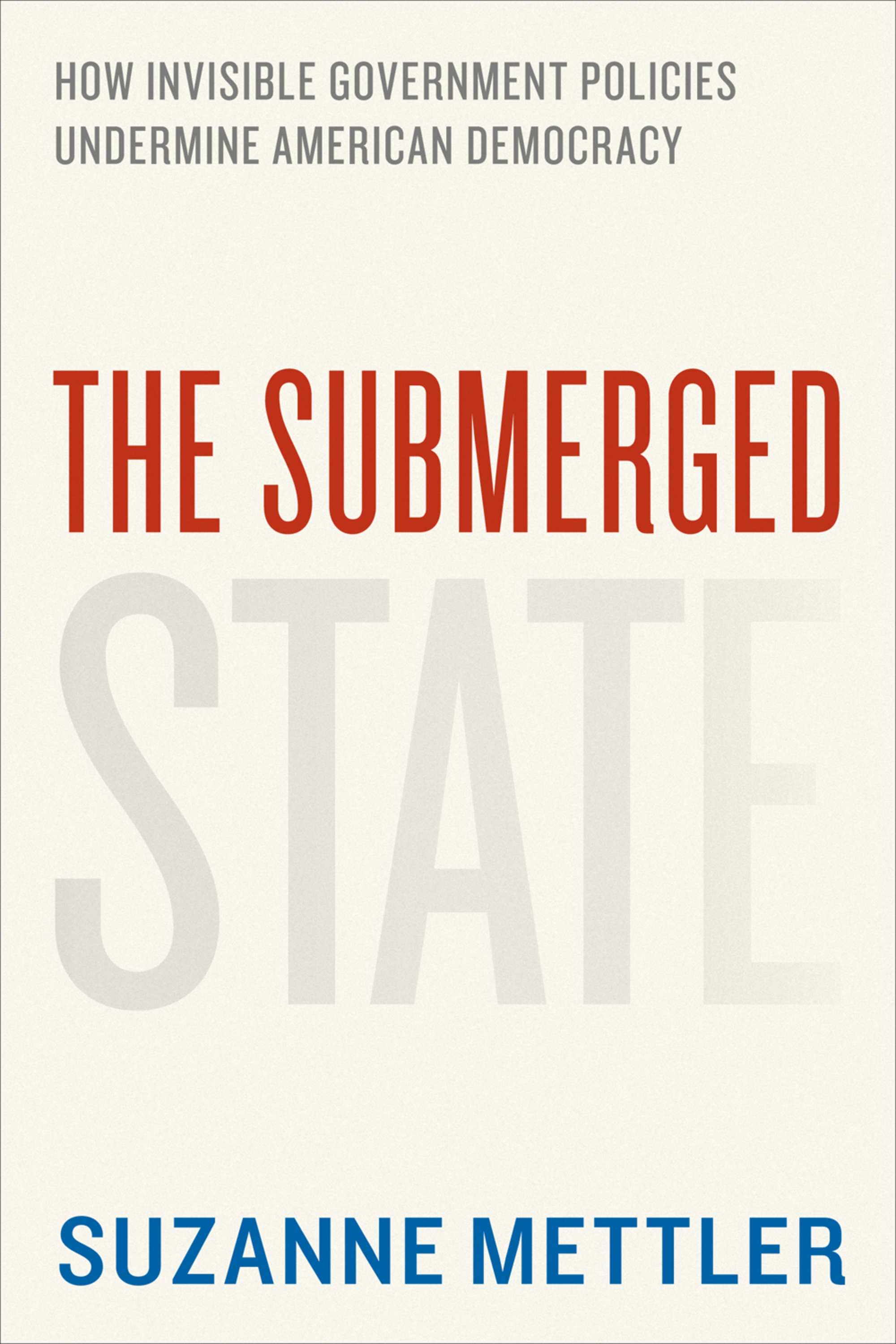
The Submerged State “Keep your government hands off my Medicare!†Such comments spotlight a central question animating Suzanne Mettler’s provocative and timely book: why are many Americans unaware of government social benefits and so hostile to them in principle, even though they receive them? The Obama administration has been roundly criticized for its inability to convey how much it has accomplished for ordinary citizens. Mettler argues that this difficulty is not merely a failure of communication; rather it is endemic to the formidable presence of the “submerged state.†In recent decades, federal policymakers have increasingly shunned the outright disbursing of benefits to individuals and families and favored instead less visible and more indirect incentives and subsidies, from tax breaks to payments for services to private companies. These submerged policies, Mettler shows, obscure the role of government and exaggerate that of the market. As a result, citizens are unaware not only of the benefits they receive, but of the massive advantages given to powerful interests, such as insurance companies and the financial industry. Neither do they realize that the policies of the submerged state shower their largest benefits on the most affluent Americans, exacerbating inequality. Mettler analyzes three Obama reforms—student aid, tax relief, and health care—to reveal the submerged state and its consequences, demonstrating how structurally difficult it is to enact policy reforms and even to obtain public recognition for achieving them. She concludes with recommendations for reform to help make hidden policies more visible and governance more comprehensible to all Americans. The sad truth is that many American citizens do not know how major social programs work—or even whether they benefit from them. Suzanne Mettler’s important new book will bring government policies back to the surface and encourage citizens to reclaim their voice in the political process. POLITICAL SCIENCE,General

New British Fascism The British National Party (BNP) is the most successful far right party in British political history. Based on unprecedented access to the party and its members, this book examines the rise of the BNP and explains what drives some citizens to support far right politics. It is essential reading for all those with an interest in British politics, extremism, voting, race relations and community cohesion. The book helps us understand: how wider trends in society have created a favourable climate for the far right; how the far right has presented a ‘modernised’ ideology and image; how the movement is organized, and has evolved over time; who votes for the far right and why; why people join, become and remain actively involved in far right parties. POLITICAL SCIENCE,General
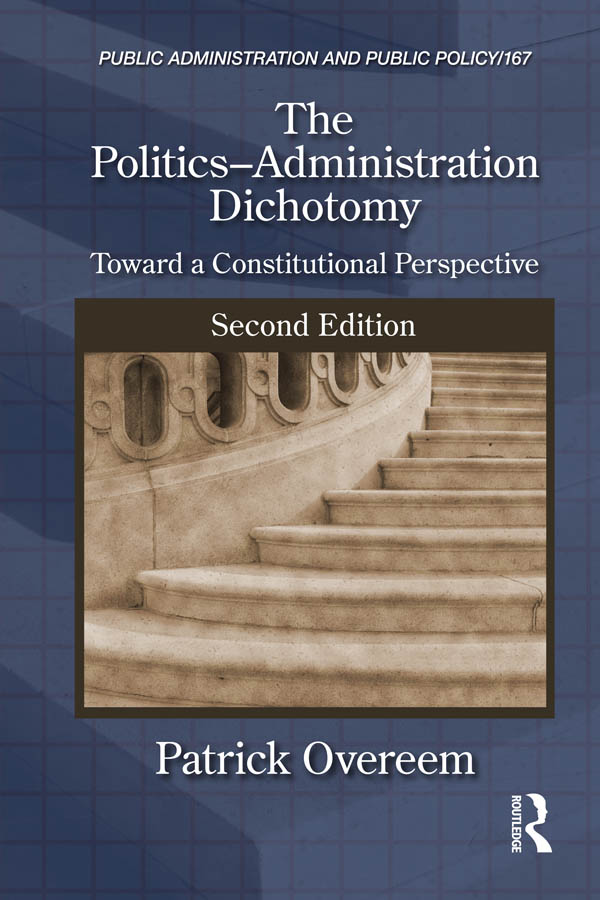
The Politics-Administration Dichotomy The politics-administration dichotomy is much mentioned and often criticized in the Public Administration literature. The Politics-Administration Dichotomy: Toward a Constitutional Perspective, Second Edition offers a book-length treatment of this classical notion. While public administration academics typically reject it as an outdated and even dangerous idea, it re-emerges implicitly in their analyses. This book tells the story of how this has happened and suggests a way to get out of the quandary. It analyzes the dichotomy position in terms of content, purpose, and relevance. What’s in the Second Edition Extensive study of the politics-administration dichotomy as a classic idea in Public Administration A much-overlooked constitutionalist line of argument in defense of this widely discredited notion Exploration and further development of the intellectual legacy of Dwight Waldo Coverage of the dichotomy’s conceptual origins in 18th and 19th century Continental-European thought An assessment of main criticisms against and alternatives for the dichotomy presented in the literature Contributions to the newly emerging Constitutional School in the study of public administration An argument against the institutional separation of Political Science and Public Administration in academia Completely revised and updated, the book examines the idea that politics and public administration should be separated in our theories and practices of government. A combination of history of ideas and theoretical analysis, it reconstructs the dichotomy’s conceptual origins and classical understandings and gives an assessment of the main criticisms raised against it and the chief alternatives suggested for it. Arguing that one-sided interpretations have led to the dichotomy’s widespread but wrongful dismissal, the study shows how it can be recovered as a meaningful idea when understood as a constitutional principle. This study helps readers make sense of highly confused debates and challenge the issues with an original and provocative stance. POLITICAL SCIENCE,General
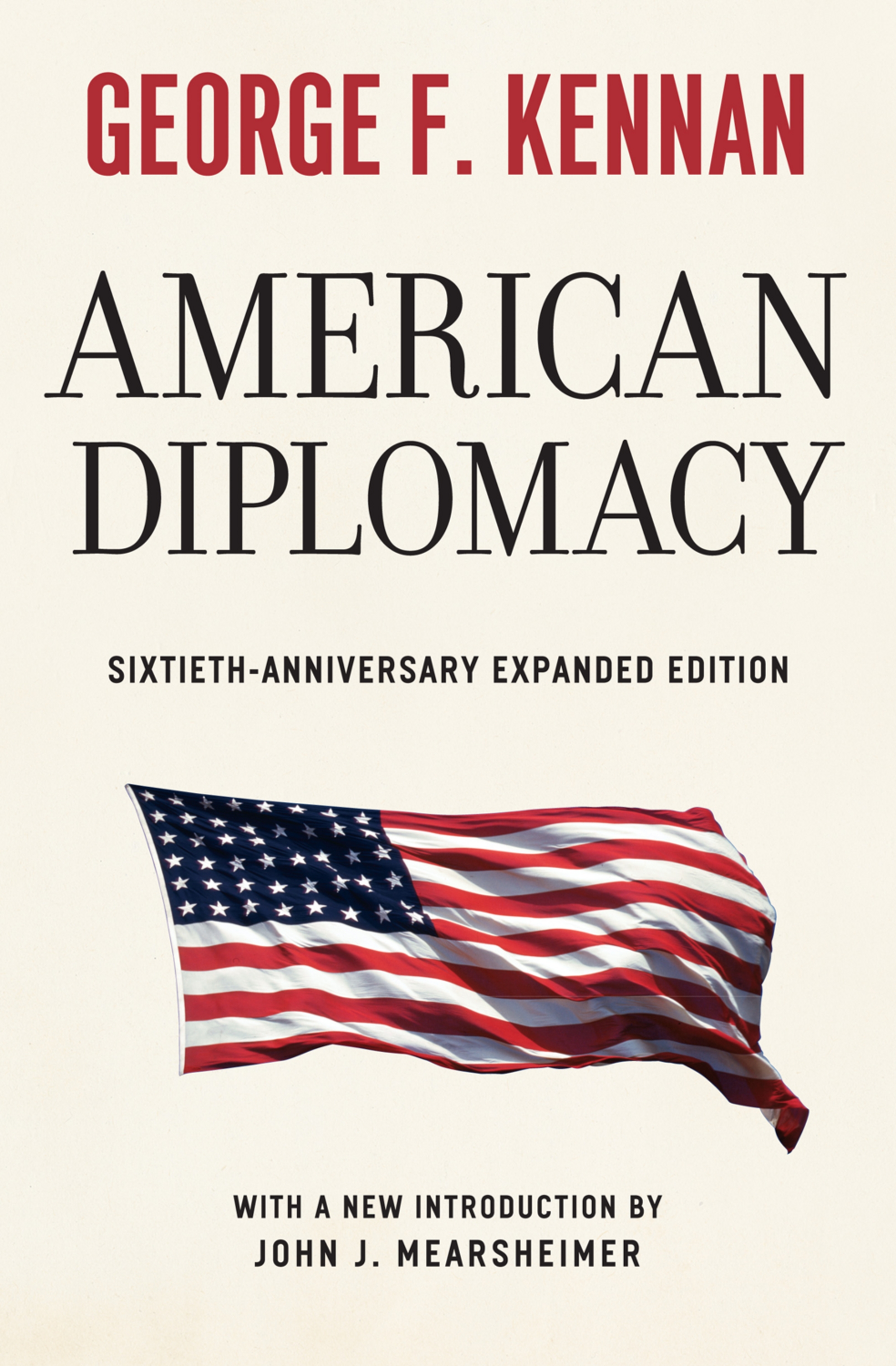
American Diplomacy For more than sixty years, George F. Kennan’s American Diplomacy has been a standard work on American foreign policy. Drawing on his considerable diplomatic experience and expertise, Kennan offers an overview and critique of the foreign policy of an emerging great power whose claims to rightness often spill over into self-righteousness, whose ambitions conflict with power realities, whose judgmentalism precludes the interests of other states, and whose domestic politics frequently prevent prudent policies and result in overstretch. Keenly aware of the dangers of military intervention and the negative effects of domestic politics on foreign policy, Kennan identifies troubling inconsistencies in the areas between actions and ideals—even when the strategies in question turned out to be decided successes. In this expanded sixtieth-anniversary edition, a substantial new introduction by John J. Mearsheimer, one of America’s leading political realists, provides new understandings of Kennan’s work and explores its continued resonance. As America grapples with its new role as one power among many—rather than as the “indispensable nation†that sees “further into the futureâ€â€”Kennan’s perceptive analysis of the past is all the more relevant. Today, as then, the pressing issue of how to wield power with prudence and responsibility remains, and Kennan’s cautions about the cost of hubris are still timely. Refreshingly candid, American Diplomacy cuts to the heart of policy issues that continue to be hotly debated today. “These celebrated lectures, delivered at the University of Chicago in 1950, were for many years the most widely read account of American diplomacy in the first half of the twentieth century.â€â€”Foreign Affairs, Significant Books of the Last 75 Years POLITICAL SCIENCE,General
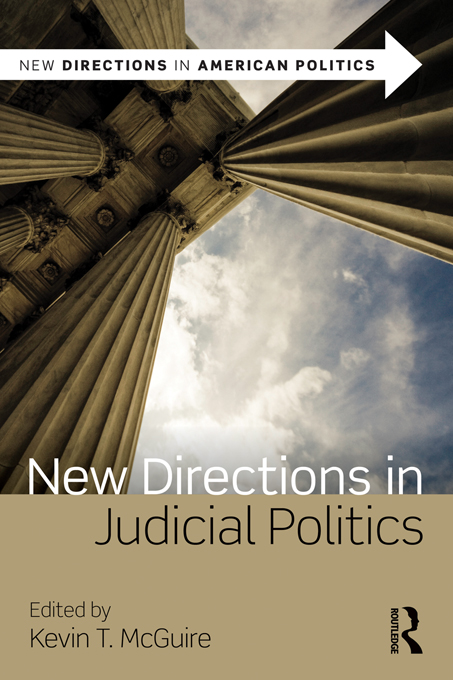
New Directions in Judicial Politics With its often vague legal concepts and institutions that operate according to unfamiliar procedures, judicial decision-making is, in many respects, a highly enigmatic process. New Directions in Judicial Politics seeks to demystify the courts, offering readers the insights of empirical research to address questions that are of genuine interest to students. In addition to presenting a set of conclusions about the way in which courts operate, this book also models the craft of political research, illustrating how one can account for a variety of factors that might affect the courts and how they operate. The renowned scholars and teachers in this volume invite critical thinking, not only about the substance of law and courts in America, but also about the ways in which we study judicial politics. POLITICAL SCIENCE,General
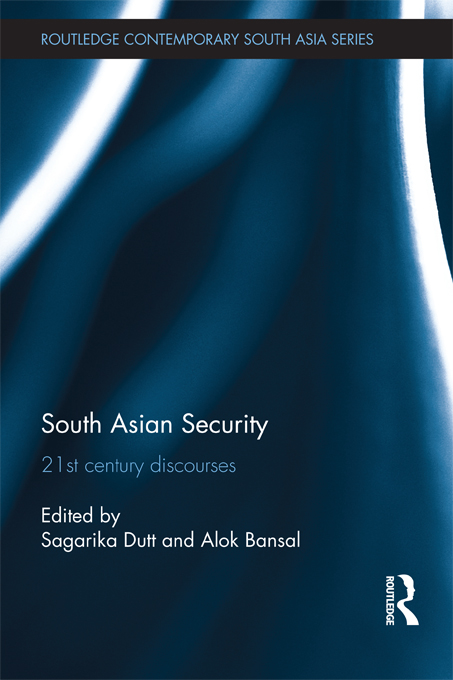
South Asian Security The South Asian security complex refers to security interdependencies between the states in the region, and also includes the effect that powerful external actors, such as China, the US and Russia, and geopolitical interests have on regional dynamics. This book focuses on the national securities of a number of South Asian countries in order to discuss a range of issues related to South Asian security. The book makes a distinction between traditional and non-traditional security. While state-centric approaches such as bilateral relations between India and Pakistan are considered to be traditional realist approaches to security, the promotion of economic, environmental and human security reflect global concerns, liberal theories and cosmopolitan values. The book goes beyond traditional security issues to reflect the changing security agenda in South Asia in the twenty-first century, and is a useful contribution to studies on South Asian Politics and Security Studies. POLITICAL SCIENCE,General

The Security Governance of Regional Organizations The Security Governance of Regional Organizations assesses the effectiveness of regional organizations as regional or global security providers, and examines how policy preferences, resources, capabilities, institutional mechanisms and economic and political cohesion link with collective action behaviour in four security policy functions. It investigates how regional organizations meet the new security threats or respond to strategic geopolitical changes and what adaptations they make in the process. Divided into three parts and using a common analytical framework, the book explains the changing security agenda in ten key regional organizations, each organizational chapter: identifies the nature of threats within the region examines the historical development and the degree of institutionalization assesses the level of governance explores the context of interaction investigates the compliance with the norms of the system of governance. This collection contributes to the ongoing reconceptualization of security and definition of security governance, and explores whether regional security governance processes are unique or similar and whether some organizational experiences can be seen as models for others to follow. It combines a coherent theoretical framework with strong comparative case studies, making it ideal reading for all students of security studies. POLITICAL SCIENCE,General
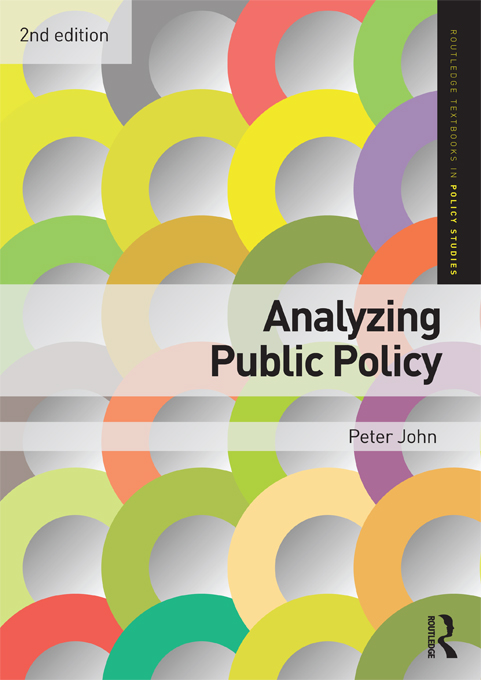
Analyzing Public Policy The fully revised and updated new edition of this textbook continues to provide the most accessible overview of the main approaches in the study of public policy. It seeks to review the most common and widely used frameworks in the study of policy analysis: institutions groups and networks society and the economy individual interests ideas. The book explains each one, offers constructive criticisms and explores their claims in the light of a variety of American, British and European examples. Arguing that no one framework offers a comprehensive explanation of public policy; John suggests a synthesis based on different aspects of the approaches, introducing concepts/approaches of advocacy coalitions, punctuated equilibrium and evolution as more effective ways to understand public policy. Combining both a clear summary of debates in public policy and a new and original approach to the subject, this book remains essential reading for students of public policy and policy analysis. POLITICAL SCIENCE,General

Power and Progress Jack Snyder is a leading American international relations scholar with an international reputation for his research on IR theory and US Foreign policy. This book collects many of his most important essays into a single volume. Exploring a liberal realist theory of international politics, the book is arranged around three key subject areas: Anarchy and Its Effects The Challenges of Democratic Consolidation Empire and the Promotion of a Liberal Order With a new introduction to frame the selected essays, this collection examines how developing nations evolve political systems, and fit into a world dominated by liberal-democracies. It looks to the future for the current dominant powers in a changing world of international relations and at the challenges to their leadership. Featuring a new conclusion, developed from the assembled chapters, this is a fascinating and vital collection of scholarship from one of the most influential theorists of his generation. Power and Progress is an invaluable text for students and scholars of international relations, and those interested in the debates on liberalism and realism, and comparative politics. POLITICAL SCIENCE,General

The Roberts Court The Roberts Court, seven years old, sits at the center of a constitutional maelstrom. Through four landmark decisions, Marcia Coyle, one of the most prestigious experts on the Supreme Court, reveals the fault lines in the conservative-dominated Court led by Chief Justice John Roberts Jr. Seven minutes after President Obama put his signature to a landmark national health care insurance program, a lawyer in the office of Florida GOP attorney general Bill McCollum hit a computer key, sparking a legal challenge to the new law that would eventually reach the nation’s highest court. Health care is only the most visible and recent front in a battle over the meaning and scope of the U.S. Constitution. The battleground is the United States Supreme Court, and one of the most skilled, insightful, and trenchant of its observers takes us close up to watch it in action. Marcia Coyle’s brilliant inside account of the High Court captures four landmark decisions—concerning health care, money in elections, guns at home, and race in schools. Coyle examines how those cases began—the personalities and conflicts that catapulted them onto the national scene—and how they ultimately exposed the great divides among the justices, such as the originalists versus the pragmatists on guns and the Second Amendment, and corporate speech versus human speech in the controversial Citizens United campaign case. Most dramatically, her analysis shows how dedicated conservative lawyers and groups are strategizing to find cases and crafting them to bring up the judicial road to the Supreme Court with an eye on a receptive conservative majority. The Roberts Court offers a ringside seat at the struggle to lay down the law of the land. POLITICAL SCIENCE,General

European Foreign Policy and the Challenges of Balkan Accession The Balkan countries have responded differently to the EU’s conditional offer of membership. This book examines the diverging compliance patterns of the Balkan accession states and asks why some of them have complied substantially, some only partially and others have defied the EU. The book examines the compliance of the Balkan states with the EU accession conditionality, arguing that the variation in the compliance behavior of Balkan governments hinges on three main factors – the legitimacy of the EU conditions as seen domestically in the accession states, the costs of compliance and the EU’s ability and willingness to use its superior power resources to impose compliance when faced with domestic defiance. Placing important events from the most recent political history of the Balkans in a broader historical perspective, the author evaluates the successes and failures of the EU’s state building policies in the Balkans, a geographical area of the highest priority for the EU’s foreign policy and a test case for the EU’s capacity and willingness for foreign policy action. Based on detailed empirical data, European Foreign Policy and the Challenges of Balkan Accession will be of interest to scholars and students of EU and comparative politics, and those focusing on policy impact in EU integration. POLITICAL SCIENCE,General

The Modern State The new edition of this well-established and highly regarded textbook continues to provide the clearest and most comprehensive introduction to the modern state. It examines the state from its historical origins at the birth of modernity to its current jeopardized position in the globalized politics of the 21st Century. The book has been entirely revised and updated throughout, including substantial new material on the financial crisis and the environment. Subjects covered include: • The evolution of the state system • Placing the state in modernity• States and societies • State and economy • States and citizens • States and the international order • States of the twenty-first century This book is essential reading for all those studying the state, international relations and comparative politics. POLITICAL SCIENCE,General

Populism in Latin America Normal0falsefalsefalseMicrosoftInternetExplorer4 This updated edition of Populism in Latin America discusses new developments in populism as a political phenomenon and the emergence of new populist political figures in Mexico, Argentina, and Venezuela in particular. For more than one hundred years—from the beginning of the twentieth to the early twenty-first century—Latin American populists proved amazingly successful at gaining high office, holding on to power, maintaining their followings, and renewing their careers. They raised more campaign money, got more voters to the polls,and held followers’ allegiances far better than traditional politicians. Certainly some populist leaders were corrupt, others manipulated their followers, and still others disgraced themselves. Nevertheless, populist leaders were extraordinarily effective in reaching masses of voters, and some left positive legacies for future generations. Populism in Latin America examines the notion of populism in the political and social culture of Latin American societies as expressed through the populist leaders of several Latin American countries including Argentina, Brazil, Mexico, Chile, Ecuador, Panama, Peru, and Venezuela. This second edition also includes a new preface by Kenneth M. Roberts, professor of comparative and Latin American politics and the Robert S. Harrison Director of the Institute for the Social Sciences at Cornell University. ContributorsJorge Basurto / Michael L. Conniff / Paul W. Drake / Steve Ellner / Joel Horowitz /Kenneth M. Roberts / W. Frank Robinson /Ximena Sosa / Steve Stein / Kurt Weyland POLITICAL SCIENCE,General
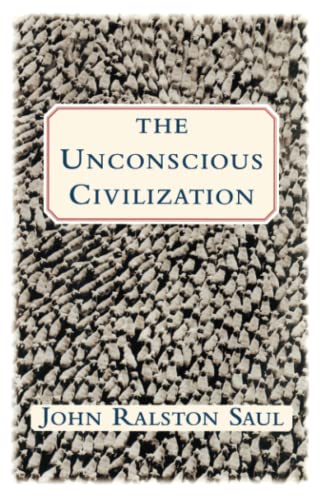
The Unconscious Civilization In this intellectual tour de force John Ralston Saul argues that our society is only superficially based on the individual and democracy, and the West now toils unconsciously in the grip of a stifling “corporatist†structure that serves the needs of business managers and technocrats as it promotes the segmentation of society into competing interest groups and ethnic blocks. POLITICAL SCIENCE,General

Understanding Comparative Politics Comparative politics has undergone significant theoretical changes in recent decades. Particularly since the 1980s, a new generation of scholars have revamped and rejuvinated the study of the subject. Mehran Kamrava examines current and past approaches to the study of comparative politics and proposes a new framework for analysis. This is achieved through a comparative examination of state and social institutions, the interactions that occur between them, and the poltical cultures within which they operate. The book also offers a concise and detailed synthesis of existing comparative frameworks that, up to now at least, have encountered analytical shortcomings on their own. Although analytically different in its arguments and emphasis from the current "Mainstream" genre of literature on comparative politics, the present study is a logical outgrowth of the scholarly works of the last decade or so. It will be essential reading for all students of comparative politics. POLITICAL SCIENCE,General
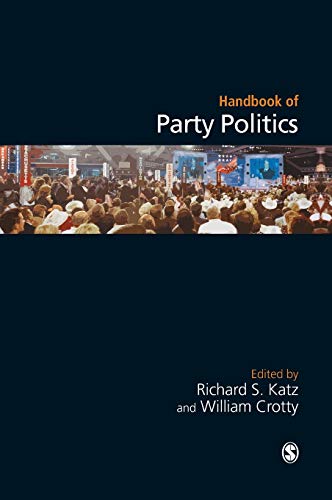
Handbook of Party Politics 'This thoughtful and wide-ranging review of parties and party research contains contributions from many of the foremost party scholars and is a must for all library shelves' - Richard Luther, Keele University Political parties are indispensable to democracy and a central subject of research and study in political science around the world. The Handbook of Party Politics is designed to provide an invaluable survey of the major theories and approaches in this dynamic area of study and research. It give students and researchers a concise `road map' to the core literatures in all the sub-fields of party related theorizing and research, identifying the theories, approaches and topics that define the current `cutting edge' of the field. POLITICAL SCIENCE,General
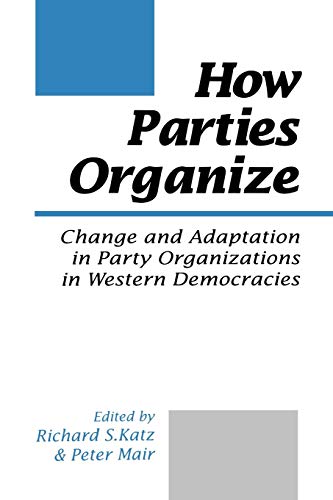
How Parties Organize This book takes a close look inside political parties, bringing together the findings of an international team of leading scholars. Building on a unique set of cross-national data on party organizations, the contributors set out to explain how parties organize, how they have changed and how they have adapted to the changing political and organizational circumstances in which they find themselves. The contributors are recognized authorities on the party systems of their countries, and have all been involved in gathering data on party membership, party finance and the internal structure of power. They add to the analysis of these original data an expert knowledge of the wider political patterns in their countries, and thus p POLITICAL SCIENCE,General
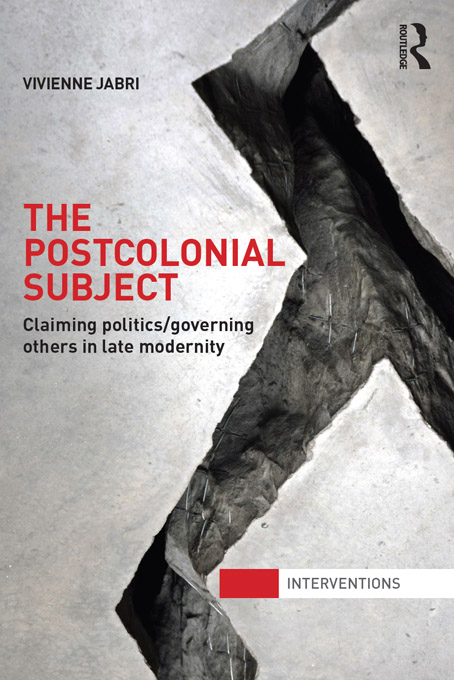
The Postcolonial Subject This book places the lens on postcolonial agency and resistance in a social and geopolitical context that has witnessed great transformations in international politics. What does postcolonial politics mean in a late modern context of interventions that seek to govern postcolonial populations? Drawing on historic and contemporary articulations of agency and resistance and highlighting voices from the postcolonial world, the book explores the transition from colonial modernity to the late modern postcolonial era. It shows that at each moment wherein the claim to politics is made, the postcolonial subject comes face to face with global operations of power that seek to control and govern. As seen in the Middle East and elsewhere, these operations have variously drawn on war, policing, as well as pedagogical practices geared at governing the political aspirations of target societies. The book provides a conceptualisation of postcolonial political subjectivity, discusses moments of its emergence, and exposes the security agendas that seek to govern it. Engaging with political thought, from Hannah Arendt, to Frantz Fanon, Michel Foucault, and Edward Said, among other critical and postcolonial theorists, and drawing on art, literature, and film from the postcolonial world, this work will be of great interest to students and scholars of critical international relations, postcolonial theory, and political theory. POLITICAL SCIENCE,General
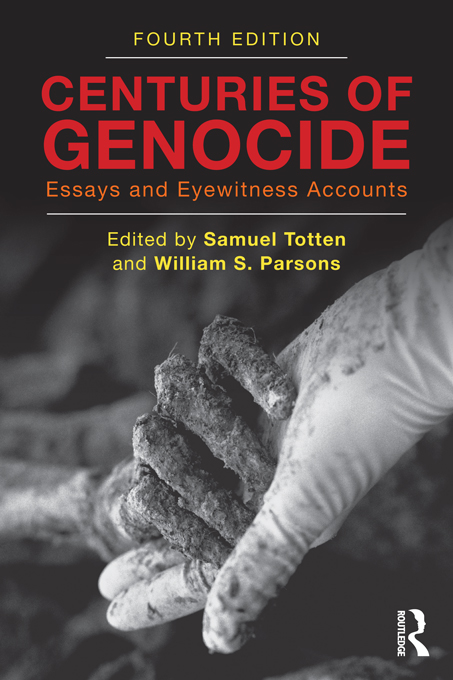
Centuries of Genocide The fourth edition of Centuries of Genocide: Essays and Eyewitness Accounts addresses examples of genocides perpetrated in the nineteenth, twentieth, and twenty-first centuries. Each chapter of the book is written by a recognized expert in the field, collectively demonstrating a wide range of disciplinary perspectives. The book is framed by an introductory essay that spells out definitional issues, as well as the promises, complexities, and barriers to the prevention and intervention of genocide. To help the reader learn about the similarities and differences among the various cases, each case is structured around specific leading questions. In every chapter authors address: Who committed the genocide? How was the genocide committed? Why was the genocide committed? Who were the victims? What were the outstanding historical forces? What was the long-range impact? What were the responses? How do scholars interpret this genocide? How does learning about this genocide contribute to the field of study? While the material in each chapter is based on sterling scholarship and wide-ranging expertise of the authors, eyewitness accounts give voice to the victims. This book is an attempt to provoke the reader into understanding that learning about genocide is important and that we all have a responsibility not to become immune to acts of genocide, especially in the interdependent world in which we live today. Revision highlights include: New chapters on genocide of Native Americans in the nineteenth century, genocide in Australia, and genocide in the Nuba Mountains New chapter authors on Herero genocide and Rwanda genocide Consolidation of the 3 chapters on the Holocaust into one focused case Several chapters from past editions that were omitted are now available on a companion website (Indonesia, Burundi, indigenous peoples) POLITICAL SCIENCE,General

The End Of An Era Tony Benn's final instalment of diaries centres on a decade which saw the disintegration of Eastern Europe, an unprecedented assault on the labour movement at home, the fall of Margaret Thatcher and the tragic war in the Gulf. It is a period which marks the peak of Tony Benn's reputation as a brilliant parliamentarian. This final volume of diaries gives us insight into an era of extraordinary international and domestic political life making it one of the most important political writings of our time. POLITICAL SCIENCE,General

Understanding Research Planning, undertaking and completing a research project – from dissertations to presentations - can be a daunting undertaking for any student, involving a number of easily taken mis-steps for those without adequate guidance. The objective of any research project is to gather data, analyse it based on your research question and present your findings and conclusions. For students, having the right approach to these steps can mean the difference between an easily handled process resulting in a well argued and presented project, or panicked flailing, misdirection and confusion. For those fearful of not getting enough research done, doing it the wrong way, putting it together incorrectly, or unsure of what the end result will be, then Understanding Research is an invaluable guide to getting it right and putting fears to bed. Successfully completing a research project is a major milestone in most university degrees, and it should be daunting – although not unassailable. This book provides students with the guidance necessary to start, undertake and present their research project in social science or the humanities. This text addresses: Where do I start? How do I begin my research and pull it together into a research question? - takes the student through the process of project design, starting research and gaining confidence in their choices Am I Researching the right things? Is it taking me in the direction I want to go? What direction is it taking me in? - explores the decision making process at all points of a research project and the implications of these decisions in the longer term Am I researching in the right way – should I be conducting interviews, reading articles or collecting statistical data? - outlines the practical and philosophical conundrums around specific techniques for gathering and analysing data Focussed explicitly on the needs and experiences of students and including a wealth of practical tips, this work is an essential resource for all students embarking on a research project. Understanding Research includes: 90 illustrations 2 tables 21 text boxes Glossary Further Reading guides for each chapter POLITICAL SCIENCE,General

Six Crises For many years before he became President, Richard Nixon's decisions vitally affected the well-being of the nation. Six of those decisions significantly shaped the man who would later become the 37th President of the United States. Six Crises is a close-up look at this dynamic man, recalling the demands placed upon him, the thinking behind his decisions, and the pressures of political life. POLITICAL SCIENCE,General
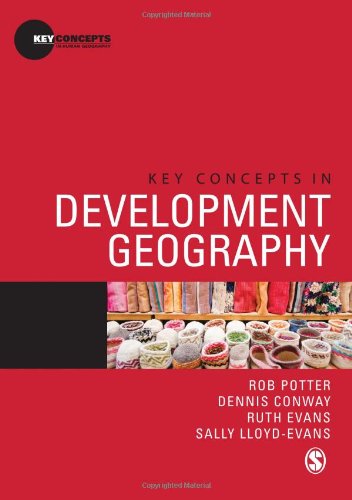
Key Concepts in Development Geography An accessible and thought-provoking survey of this vast field. Emphasising the underlying concepts students need to understand and authored by world-renowned experts. POLITICAL SCIENCE,General

My Name Is Jody Williams As Eve Ensler says in her inspired foreword to this book, "Jody Williams is many things—a simple girl from Vermont, a sister of a disabled brother, a loving wife, an intense character full of fury and mischief, a great strategist, an excellent organizer, a brave and relentless advocate, and a Nobel Peace Prize winner. But to me Jody Williams is, first and foremost, an activist." From her modest beginnings to becoming the tenth woman—and third American woman—to receive the Nobel Peace Prize, Jody Williams takes the reader through the ups and downs of her tumultuous and remarkable life. In a voice that is at once candid, straightforward, and intimate, Williams describes her Catholic roots, her first step on a long road to standing up to bullies with the defense of her deaf brother Stephen, her transformation from good girl to college hippie at the University of Vermont, and her protest of the war in Vietnam. She relates how, in 1981, she began her lifelong dedication to global activism as she battled to stop the U.S.-backed war in El Salvador. Throughout the memoir, Williams underlines her belief that an "average woman"—through perseverance, courage and imagination—can make something extraordinary happen. She tells how, when asked if she’d start a campaign to ban and clear anti-personnel mines, she took up the challenge, and the International Campaign to Ban Landmines (ICBL) was born. Her engrossing account of the genesis and evolution of the campaign, culminating in 1997 with the Nobel Peace Prize, vividly demonstrates how one woman’s commitment to freedom, self-determination, and human rights can have a profound impact on people all over the globe. POLITICAL SCIENCE,General
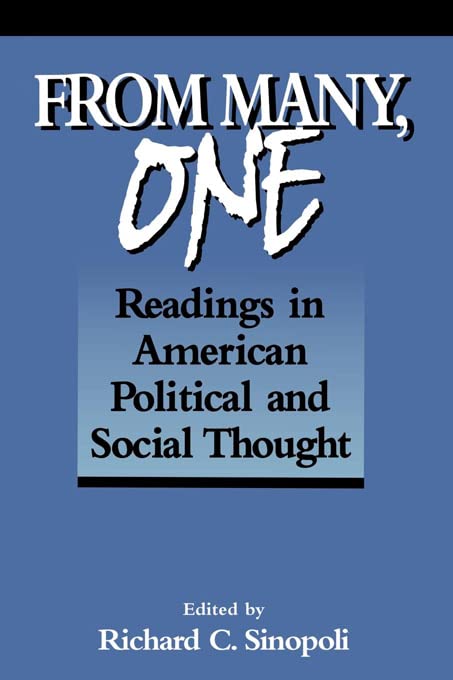
From Many, One Unique among readers in American political and social thought, From Many, One is a broad and balanced anthology that explores the problem of diversity and American political identity throughout American history. From the classic texts of the American political tradition to diverse minority writings, this book offers a wide spectrum of ideas about identity, gender, immigration, race, and religion, and addresses how these issues relate to the concept of national unity. Covering the gamut of viewpoints from majority to minority, from conservative to radical, from assimilationist to separatist, the authors range from the Founding Fathers to Frederick Jackson Turner, from Abigail Adams to bell hooks and Catharine MacKinnon; from Abraham Lincoln to Malcolm X; from Roger Williams to Ralph E. Reed. Sinopoli's extensive introductory and concluding essays set the context for and draw out the implications of the fifty readings. The conclusion includes case studies of three minority groups—homosexuals, Mexican-Americans, and Chinese-Americans—to illustrate further the themes of the volume. Brief introductions to each reading and to each of the five sections provide background information. In examining one of the central questions of American public life—the issue of national diversity—From Many, One will be a useful text for courses in American political thought, sociology, American Studies, and American history. POLITICAL SCIENCE,General

Isaiah Berlin and the Politics of Freedom Since his death in 1997, Isaiah Berlin’s writings have generated continual interest among scholars and educated readers, especially in regard to his ideas about liberalism, value pluralism, and "positive" and "negative" liberty. Most books on Berlin have examined his general political theory, but this volume uses a contemporary perspective to focus specifically on his ideas about freedom and liberty. Isaiah Berlin and the Politics of Freedom brings together an integrated collection of essays by noted and emerging political theorists that commemorate in a critical spirit the recent 50th anniversary of Isaiah Berlin’s famous lecture and essay, "Two Concepts of Liberty." The contributors use Berlin’s essay as an occasion to rethink the larger politics of freedom from a twenty-first century standpoint, bringing Berlin’s ideas into conversation with current political problems and perspectives rooted in postcolonial theory, feminist theory, democratic theory, and critical social theory. The editors begin by surveying the influence of Berlin’s essay and the range of debates about freedom that it has inspired. Contributors’ chapters then offer various analyses such as competing ways to contextualize Berlin’s essay, how to reconsider Berlin’s ideas in light of struggles over national self-determination, European colonialism, and racism, and how to view Berlin’s controversial distinction between so-called "negative liberty" and "positive liberty." By relating Berlin’s thinking about freedom to competing contemporary views of the politics of freedom, this book will be significant for both scholars of Berlin as well as people who are interested in larger debates about the meaning and conditions of freedom. POLITICAL SCIENCE,General

Caring Democracy Americansnow face a caring deficit: there are simply too many demands on people’s timefor us to care adequately for our children, elderly people, and ourselves.At the same time, political involvement inthe United States is at an all-time low, and although political life shouldhelp us to care better, people see caring as unsupported by public life anddeem the concerns of politics as remote from their lives. Caring Democracy argues that we need to rethink American democracy,as well as our fundamental values and commitments, from a caring perspective. Whatit means to be a citizen is to be someone who takes up the challenge: howshould we best allocate care responsibilities in society? Joan Tronto argues that we need tolook again at how gender, race, class, and market forces misallocate caringresponsibilities and think about freedom and equality from the standpoint of makingcaring more just.The idea thatproduction and economic life are the most important political and humanconcerns ignores the reality that caring, for ourselves and others, should bethe highest value that shapes how we view the economy, politics, andinstitutions such as schools and the family. Care is at the center of our humanlives, but Tronto argues it is currently too far removed from the concerns ofpolitics. Caring Democracy traces the reasons for this disconnection andargues for the need to make care, not economics, the central concern ofdemocratic political life. POLITICAL SCIENCE,General
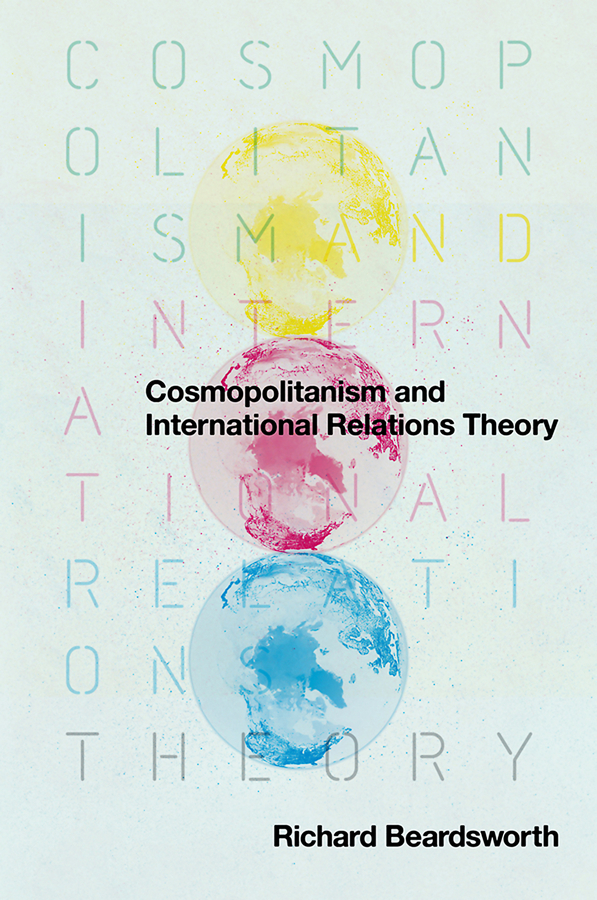
Cosmopolitanism and International Relations Theory Globalization has been contested in recent times. Among the critical perspectives is cosmopolitanism. Yet, with the exception of normative theory, international relations as a field has ignored cosmopolitan thinking. This book redresses this gap and develops a dialogue between cosmopolitanism and international relations. The dialogue is structured around three debates between non-universalist theories of international relations and contemporary cosmopolitan thought. The theories chosen are realism, (post-)Marxism and postmodernism. All three criticize liberalism in the international domain, and, therefore, cosmopolitanism as an offshoot of liberalism. In the light of each school's respective critique of universalism, the book suggests both the importance and difficulty of the cosmopolitan perspective in the contemporary world. Beardsworth emphasizes the need for global leadership at nation-state level, re-embedding of the world economy, a cosmopolitan politics of the lesser violence, and cosmopolitan political judgement. He also suggests research agendas to situate further contemporary cosmopolitanism in international relations theory. This book will appeal to all students of political theory and international relations, especially those who are seeking more articulation of the main issues between cosmopolitanism and its critics in international relations. POLITICAL SCIENCE,General

China's Environmental Challenges China’s huge environmental challenges are significant for us all. They affect not only the health and well-being of China but the very future of the planet. In this trailblazing book, noted China specialist and environmentalist Judith Shapiro investigates China’s struggle to achieve sustainable development against a backdrop of acute rural poverty and soaring middle class consumption. Using five core analytical concepts to explore the complexities of this struggle - the implications of globalization, the challenges of governance; contested national identity, the evolution of civil society and problems of environmental justice and equity - Shapiro poses a number of pressing questions: Do the Chinese people have the right to the higher living standards enjoyed in the developed world? Are China's environmental problems so severe that they may shake the government's stability, legitimacy and control? To what extent are China’s environmental problems due to patterns of Western consumption? And in a world of increasing limits on resources and pollution "sinks," is it even possible to build an equitable system in which people enjoy equal access to resources without taking them from successive generations, from the poor, or from other species? China and the planet are at a pivotal moment; the path towards a more sustainable development model is still open. But - as Shapiro persuasively argues - making this choice will require humility, creativity, and a rejection of business as usual. The window of opportunity will not be open much longer. Chapter 1 - 'The Big Picture' - is available online. POLITICAL SCIENCE,General
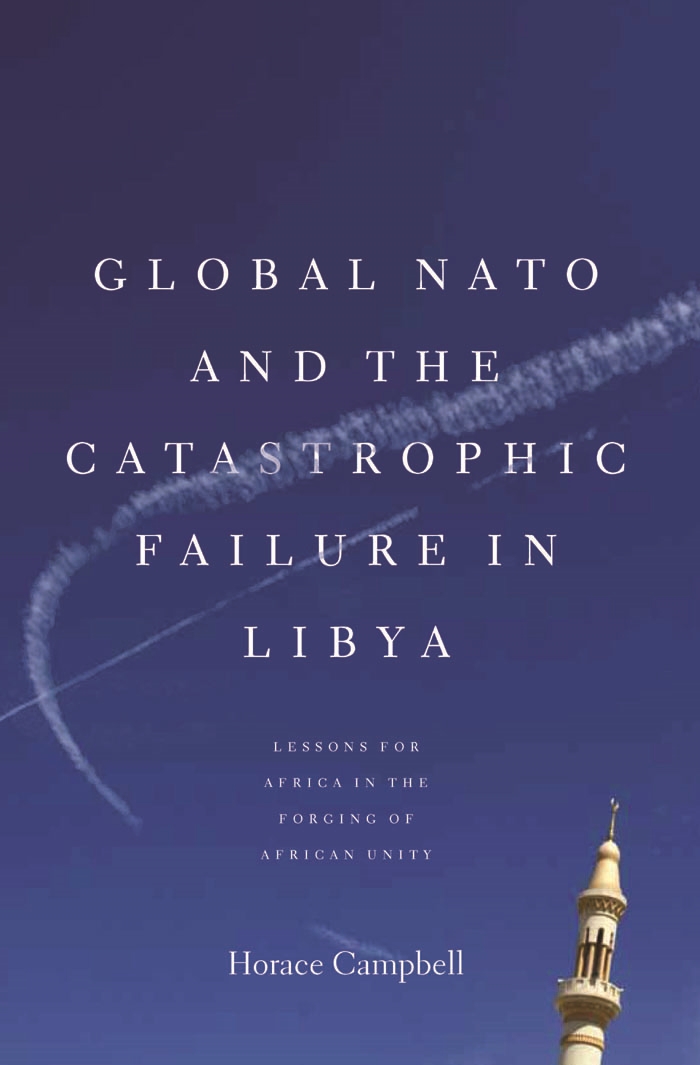
Global NATO and the Catastrophic Failure in Libya In this incisive account, scholar Horace Campbell investigates the political and economic crises of the early twenty-first century through the prism of NATO’s intervention in Libya. He traces the origins of the conflict, situates it in the broader context of the Arab Spring uprisings, and explains the expanded role of a post-Cold War NATO. This military organization, he argues, is the instrument through which the capitalist class of North America and Europe seeks to impose its political will on the rest of the world, however warped by the increasingly outmoded neoliberal form of capitalism. The intervention in Libya—characterized by bombing campaigns, military information operations, third party countries, and private contractors—exemplifies this new model.Campbell points out that while political elites in the West were quick to celebrate the intervention in Libya as a success, the NATO campaign caused many civilian deaths and destroyed the nation’s infrastructure. Furthermore, the instability it unleashed in the forms of militias and terrorist groups have only begun to be reckoned with, as the United States learned when its embassy was attacked and personnel, including the ambassador, were killed. Campbell’s lucid study is essential reading for anyone seeking to understand this complex and weighty course of events. POLITICAL SCIENCE,General
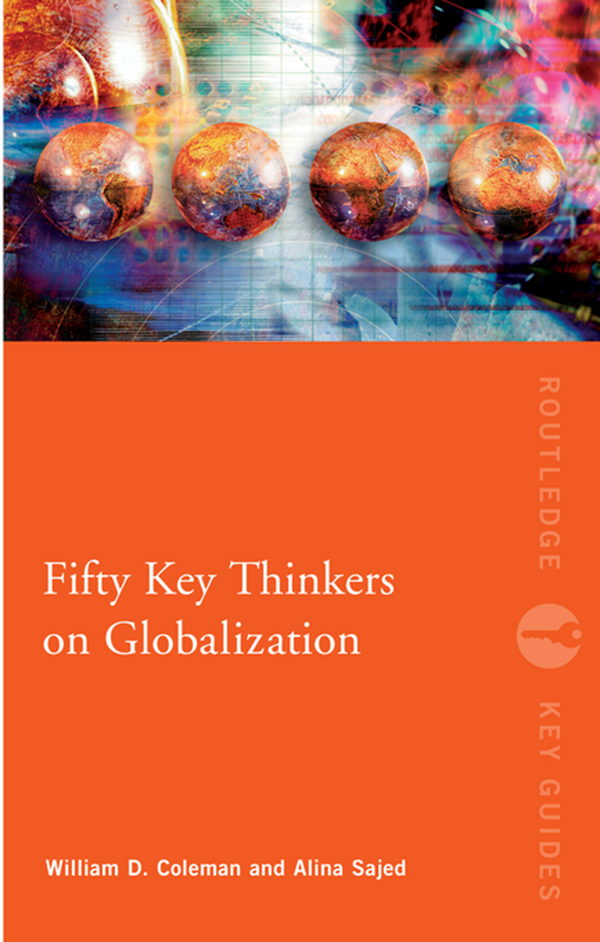
Fifty Key Thinkers on Globalization Fifty Key Thinkers on Globalization is an outstanding guide to often-encountered thinkers whose ideas have shaped, defined and influenced this new and rapidly growing field. The authors clearly and lucidly survey the life, work and impact of fifty of the most important theorists of globalization including: Manuel Castells Joseph Stiglitz David Held Jan Aart Scholte Each thinker’s contribution to the field is evaluated and assessed, and each entry includes a helpful guide to further reading. Fully cross-referenced throughout, this remarkable reference guide is essential reading for students of politics and international relations, economics, sociology, history, anthropology and literary studies. POLITICAL SCIENCE,General

Dismantlement and Destruction of Chemical, Nuclear and Conventional Weapons Proceedings of the NATO Advanced Research Workshop, Bonn, Germany, 19-21 May 1996 POLITICAL SCIENCE,General

Governance - Regieren in komplexen Regelsystemen Governance: Ein Modebegriff oder ein sinnvolles wissenschaftliches Konzept? Das Buch erläutert das Konzept in unterschiedlichen Diskussionszusammenhängen und begründet seine Relevanz. POLITICAL SCIENCE,General
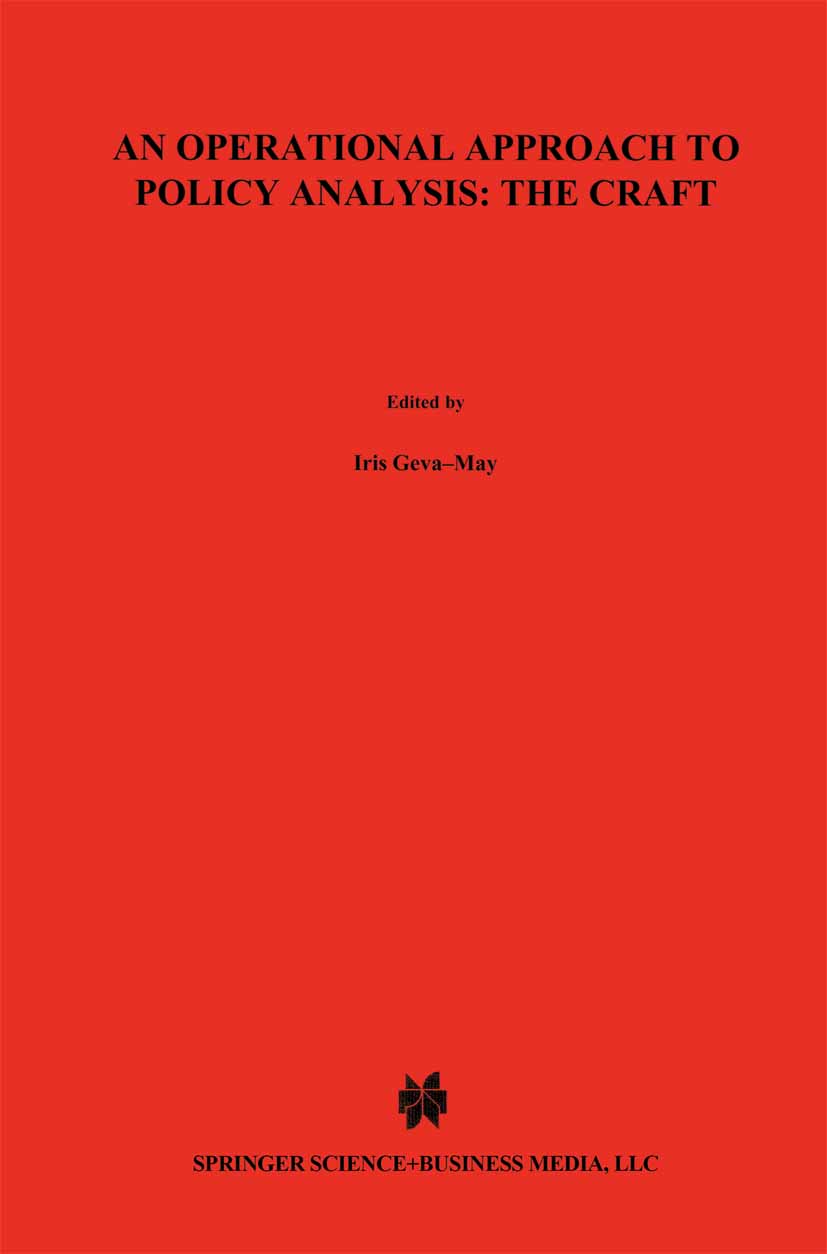
An Operational Approach to Policy Analysis The aim of An Operational Approach to Policy Analysis: The Craft is to cut through the ambiguity and contradictions inherent in policy analysis by means of an operational-prescriptive approach. Its main objective is to encapsulate the essential concepts, methods and tools of policy analysis and to provide an insight into factors acting within and around the policy analysis process. Based on the collaborative research of Iris Geva-May and Aaron Wildavsky, the first full draft of An Operational Approach to Policy Analysis: The Craft was completed just before Dr Wildavsky's untimely death. Since that time, Dr Geva-May has worked to thoroughly revise and update the manuscript. An Operational Approach to Policy Analysis: The Craft can be used by researchers in political science, or as a textbook for any course in policy analysis, policy planning and evaluation. It will serve as a valuable source for students of political science, public policy, administration and management, as well as for policy analysts, researchers and executives in both the US and abroad. POLITICAL SCIENCE,General

Economics of Income Redistribution While income redistribution is one of the most important functions of modern governments, the world has changed greatly since this first edition of Economics of Income Redistribution was published in 1983. Pension systems and medical programs are in a state of crisis in many parts of the world and the general political mood is shifting away from income redistribution. Economics of Income Redistribution (2nd edition) brings this work up to date by discussing the economic and political aspects of income redistribution. It examines the classical moral objective of redistribution to assist the poor, as well as income transfer for pensions, education and intra-family gift giving. POLITICAL SCIENCE,General
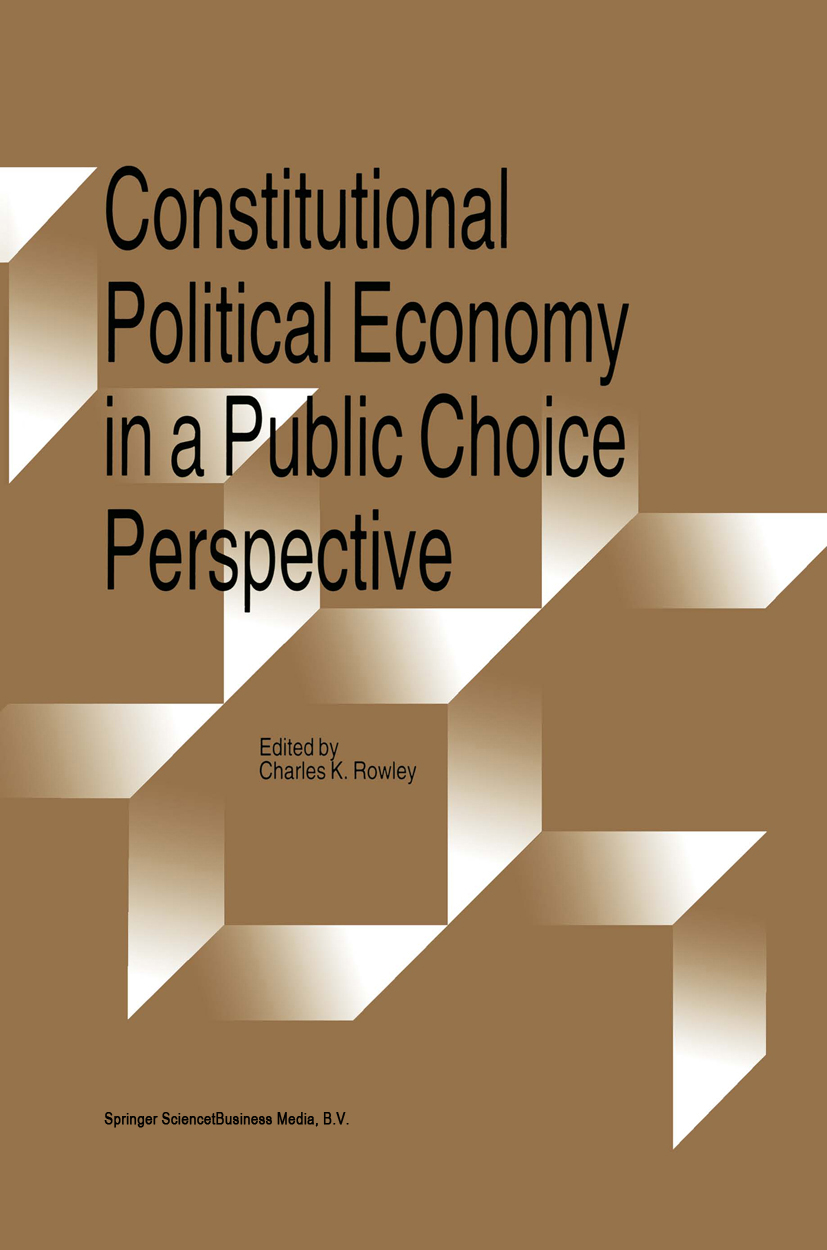
Constitutional Political Economy in a Public Choice Perspective Constitutional political economy is a research program that directs inquiry to the working properties of rules and institutions within which individuals interact and to the processes through which these rules and institutions are chosen or come into being. This book makes the case for an approach to constitutional political economy that is grounded in consistent, hard-nosed public choice analysis. Effective institutional design is simply not feasible unless the designers build their structures to withstand rational choice pressures from the political market place. If mean, sensual man is here to stay, then let us, in our better moments, incorporate that knowledge into the institutions that must govern his behavior. A distinguished list of public choice scholars pursue this approach against a varying backcloth of constitutional issues relevant to the United States, Canada, Western Europe, the transition economies and the third world. POLITICAL SCIENCE,General
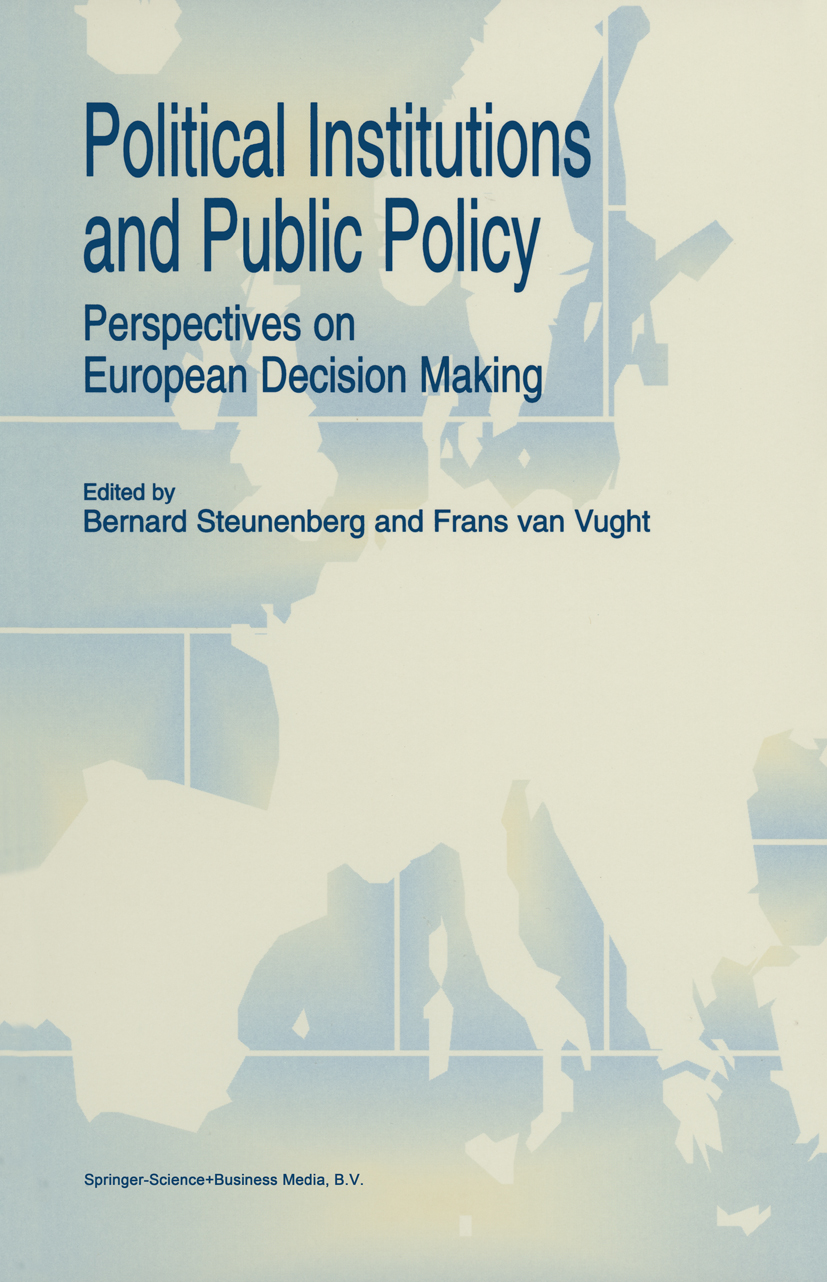
Political Institutions and Public Policy The discipline of public administration and public policy is experiencing a renaissance of research in which explicit attention is paid to political insti tutions. This renewed interest in institutions is not simply an extension of the 'classical' paradigm in the study of public administration, which peaked in the 1920s and 1930s, but offers a new orientation on political institutions. While 'classical' institutionalism is known for its focus on the formal stroctures of the executive branch of government, the 'new' institutionalism concentrates on the interaction between political institutions and the behavior of policy makers. This interaction, which until recently was largely neglected in public administration and public policy, forms the basic theme of this volume. To advance the study of political institutions, two rather basic problems need to be addressed: What are institutions and what are adequate ways to analyze them? We briefty discuss both questions, which determine the strocture of this book. POLITICAL SCIENCE,General
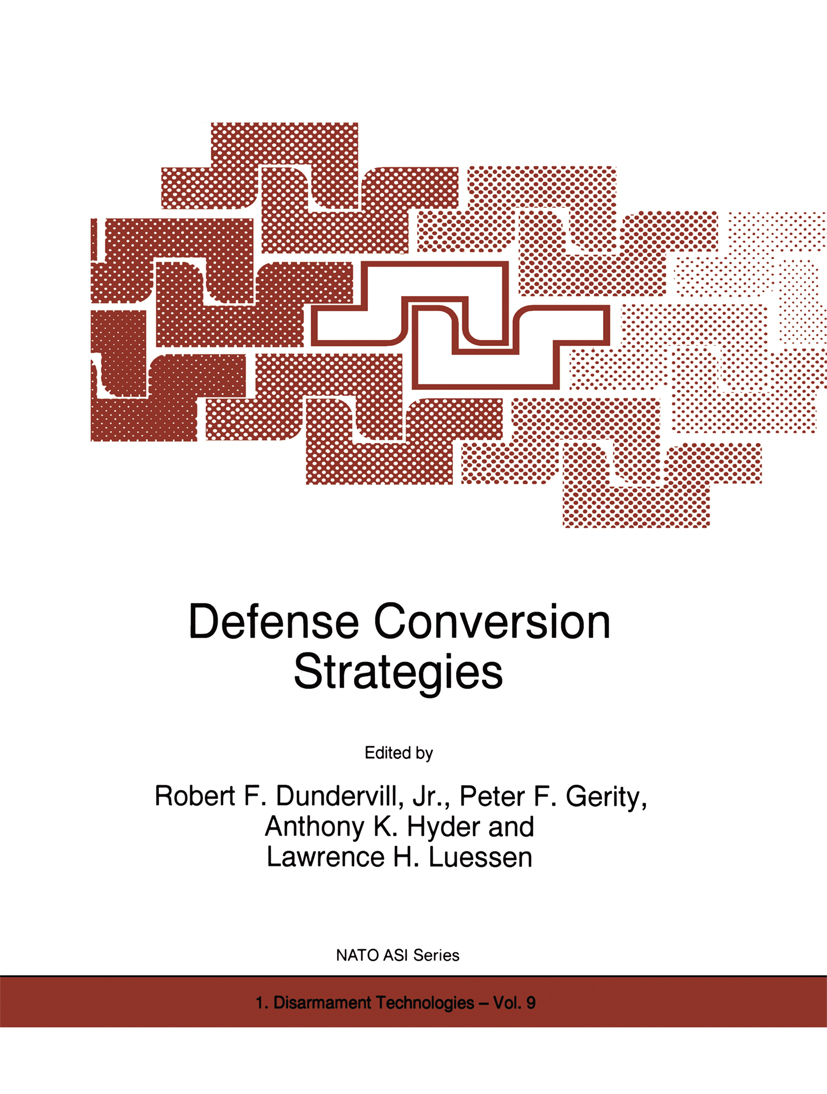
Defense Conversion Strategies Proceedings of the NATO Advanced Study Institute, Pitlochry, Perthshire, Scotland, United Kingdom, July 2-14, 1995 POLITICAL SCIENCE,General

The 1996 Bosnia-Herzegovina Elections On 14th September 1996, against the background of the Dayton agreement, six different elections took place in Bosnia-Herzegovina. This book covers in detail what was observed on the ground by 900 international observers: the voting process and the count of votes. Did the Polling Station Committee act impartially and competently? What representatives of parties or candidates were observing the elections? In which aspects do the regions in the entities Republica Srpska and the Federation Bosnia-Herzegovina differ? Did observers report specific problems in municipalities split by the Inter Entity Boundary Line? The book contributes to a clear understanding of the political climate, the role of the OSCE, and whether the elections were conducted properly. It should be of interest to students, scholars and others working in observation and analysis of elections, the political situation in Bosnia-Herzegovina, ethnic conflicts, and the role of international organisations in democratisation and peace processes. POLITICAL SCIENCE,General
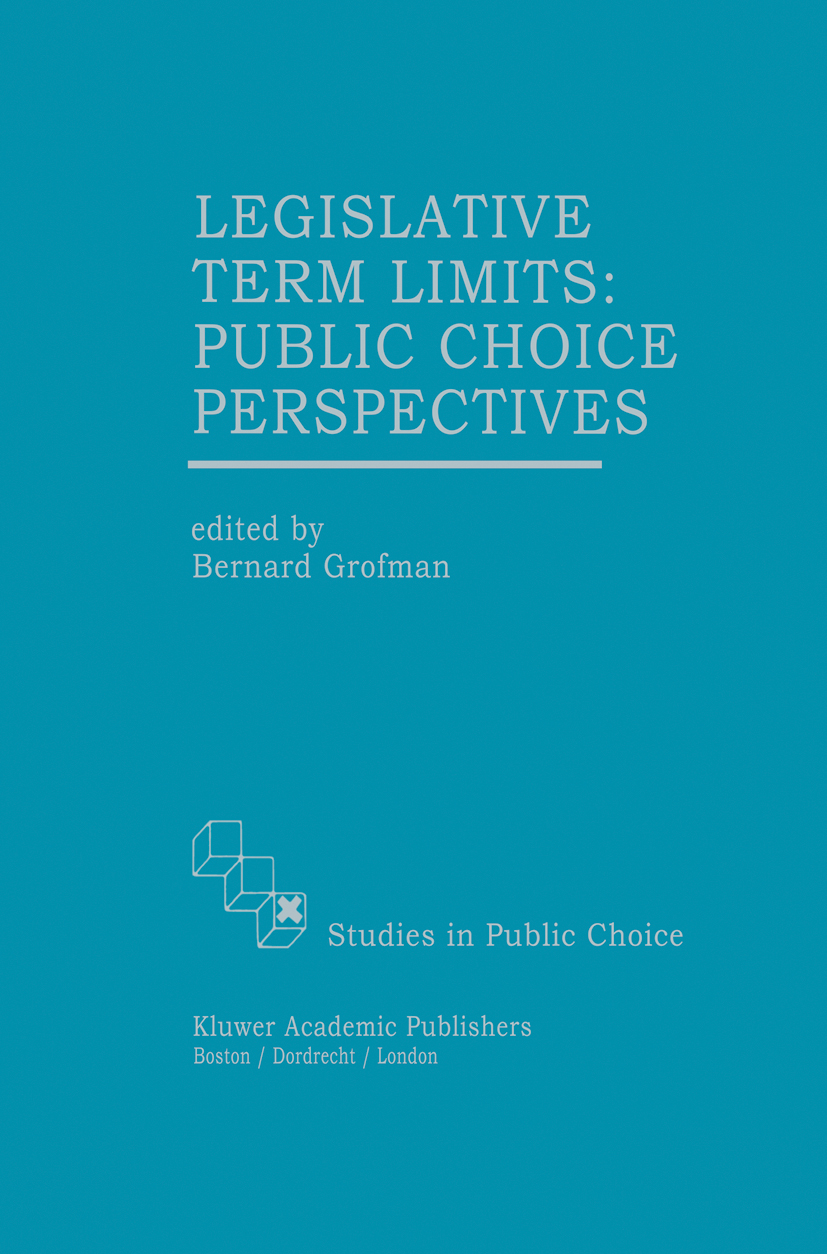
Legislative Term Limits In developing Legislative Term Limits, the editor has included material that has explicit and testable models about the expected consequences of term limits that reflect Public Choice perspectives. This book contains the best efforts of economists and political scientists to predict the consequences of legislative term limits. POLITICAL SCIENCE,General
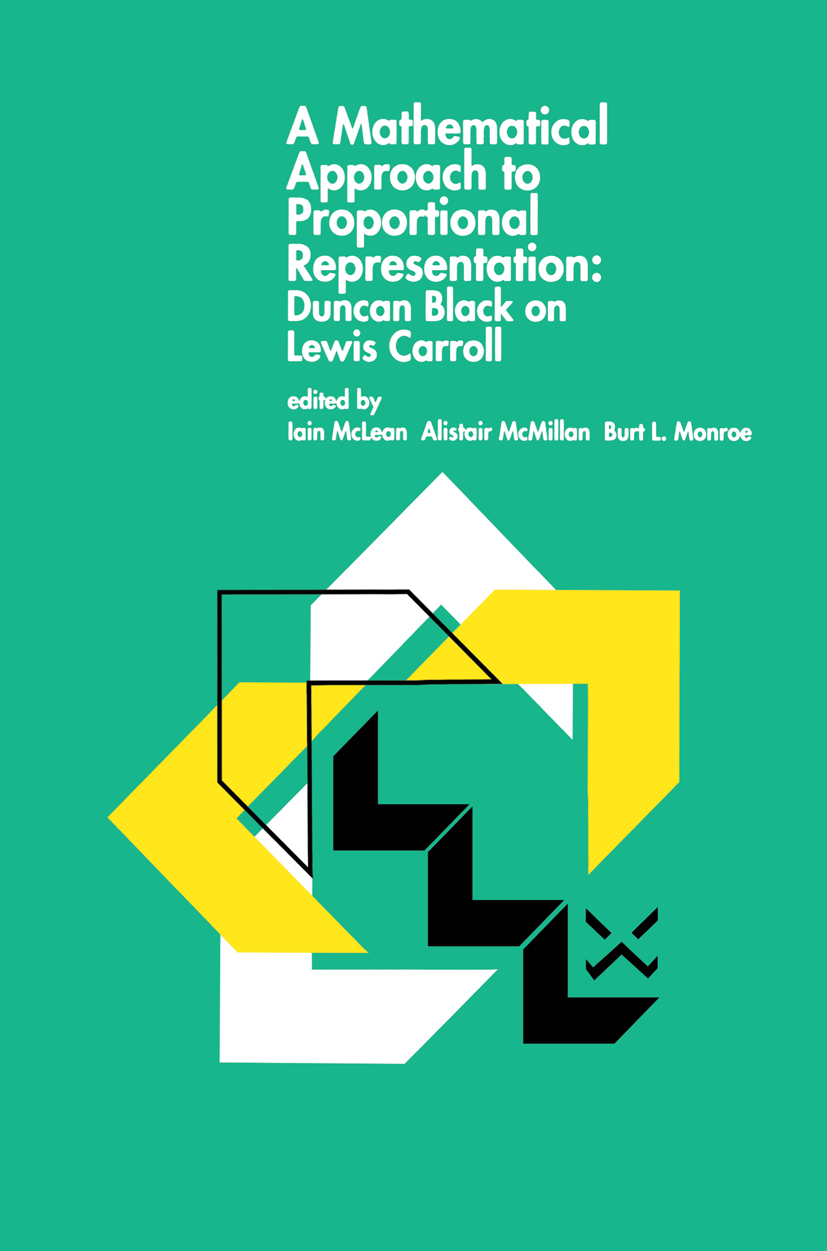
A Mathematical Approach to Proportional Representation `This is a book about a well-known writer, Lewis Carroll, and about a little-known subject, the theory of voting' (from the Editors' Introduction). This book has been edited from the manuscripts of the late Scottish economist Duncan Black. Shortly after the publication of The Theory of Committees and Elections Black started to collect material for papers and a book on Lewis Carroll's theory of proportional representation. Black's chapter plans made it clear that the book was to be in three parts, written by himself, followed by a reprint of Carroll's Principles of Parliamentary Representation and its main sources. Part I is biographical, introducing Lewis Carroll and giving relevant details of his life. Part II is Black's already published work on Lewis Carroll. Part III comprises the more detailed arguments about Carroll's reasoning, and Part IV contains reprints of rare original material on proportional representation by Carroll, James Garth Marshall, and Walter Baily. Taken together, the editors have provided a complete reference source for the theory of voting and proportional representation. POLITICAL SCIENCE,General
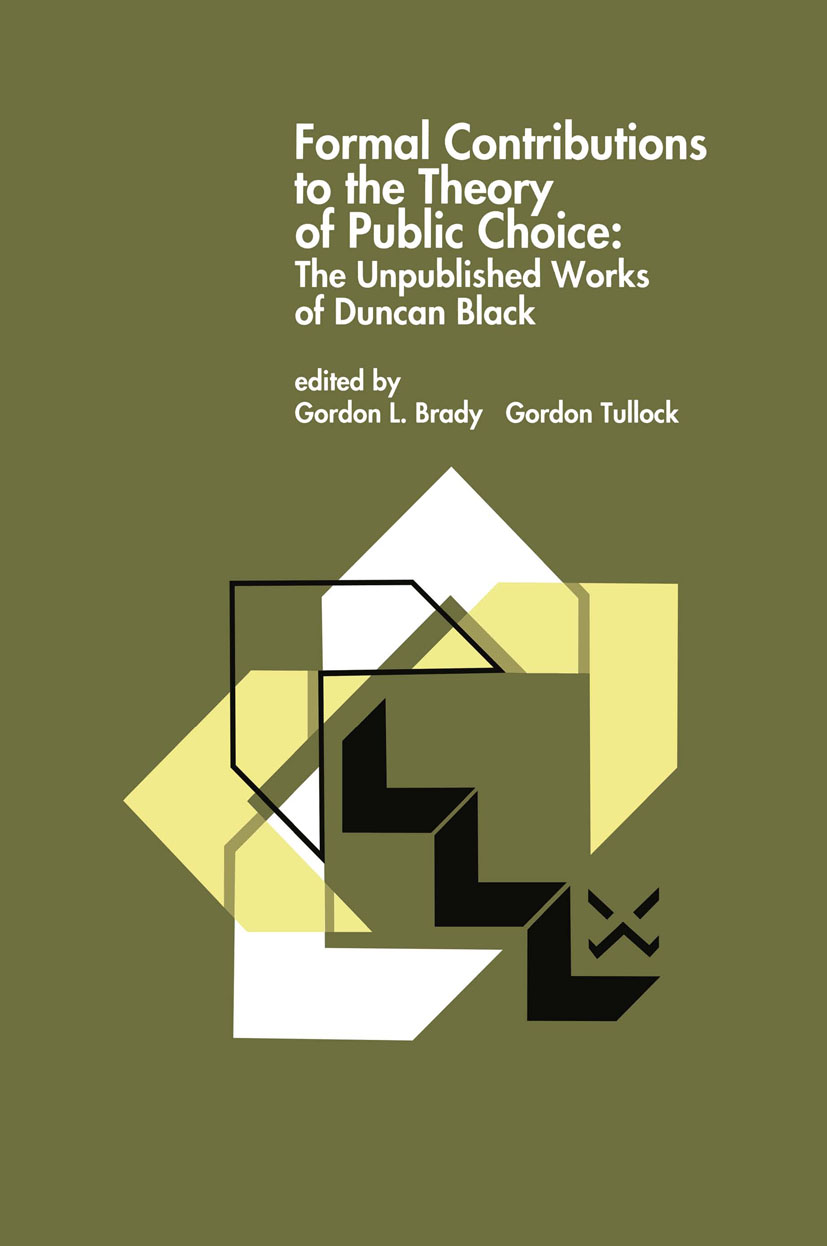
Formal Contributions to the Theory of Public Choice Duncan Black made a significant contribution to the development of public choice theory during his lifetime. Upon his death it became apparent that much of his scholarship and critique of economics was never published. Formal Contributions to the Theory of Public Choice is a collection of Duncan Black's unpublished works, representing his continuing contribution to economics and political science. It provides an insight into Black's intellectual endeavors and introduces some new ideas and extensions of earlier work. POLITICAL SCIENCE,General

The Future of the Defence Firm This book is th e result of a collaborative research project involving the Centre for Defence and Security Studies at the University of Manitoba (Canada) and the Centre for Defence Economics at the University of York in England . Perhaps not surprisingly, given its transatlantic origins, its lineage is somewhat involved. In Canada , its origins can be traced to two earlier research projects on the political economy of arms production undertaken by members of what has since become the Centre for Defence and Security Studies . The first of these , carried out in collaboration with Toronto 's York University, and financially supported by the Centre for Studies in Defence Resources Management at the National Defence College in Kingston, Ontario , was entitled " Th e Implications of Europe 1992 For Canadian Defence and Defence Industrial Interests" . The second , undertaken in conjunction with both York University and Nova Scotia's Dalhousie University , was supported by the now defunct Canadian Institute for International Peace and Security , and dealt with " N a t i o n a l Defence and the Canadian Economy . " Workshops were held in connection with both these studies, which brought together academic, governmental and industry experts in the field of defence production . POLITICAL SCIENCE,General

The Construction of Europe Stephen Martin* The fourteen essays that constitute this work provide a coherent review of the past and present of the European Community, and consider some of its possible futures. Werner Abelshauser and Richard Griffiths offer separate perspectives on the precursors of the European Community. Abelshauser argues that comparison of the fates of the European Coal and Steel Community and the European Defense Community demonstrate the dominance of political over economic considerations in the integration process. Griffiths considers the stillborn European Political Community, many of the proposed features of which, somewhat transformed, were embodied in the Treaty of Rome. Both suggest that as a practical matter a coming together of French and German interests has been a precondition for advances in European integration. Stephen Martin and Andrew Evans discuss the development of the Com munity's Structural Funds, first envisaged as tools to smooth the transition from a collection of regional economies to a continent-wide single market, now increasingly seen as devices to guide adjustment to long-term struc tural problems. Stuart Holland emphasizes the role of the Structural Funds as one element in a broad range of strategies to ensure social and economic cohesion as the Maastrict Treaty ushers the European Union into the next stage of its development. POLITICAL SCIENCE,General
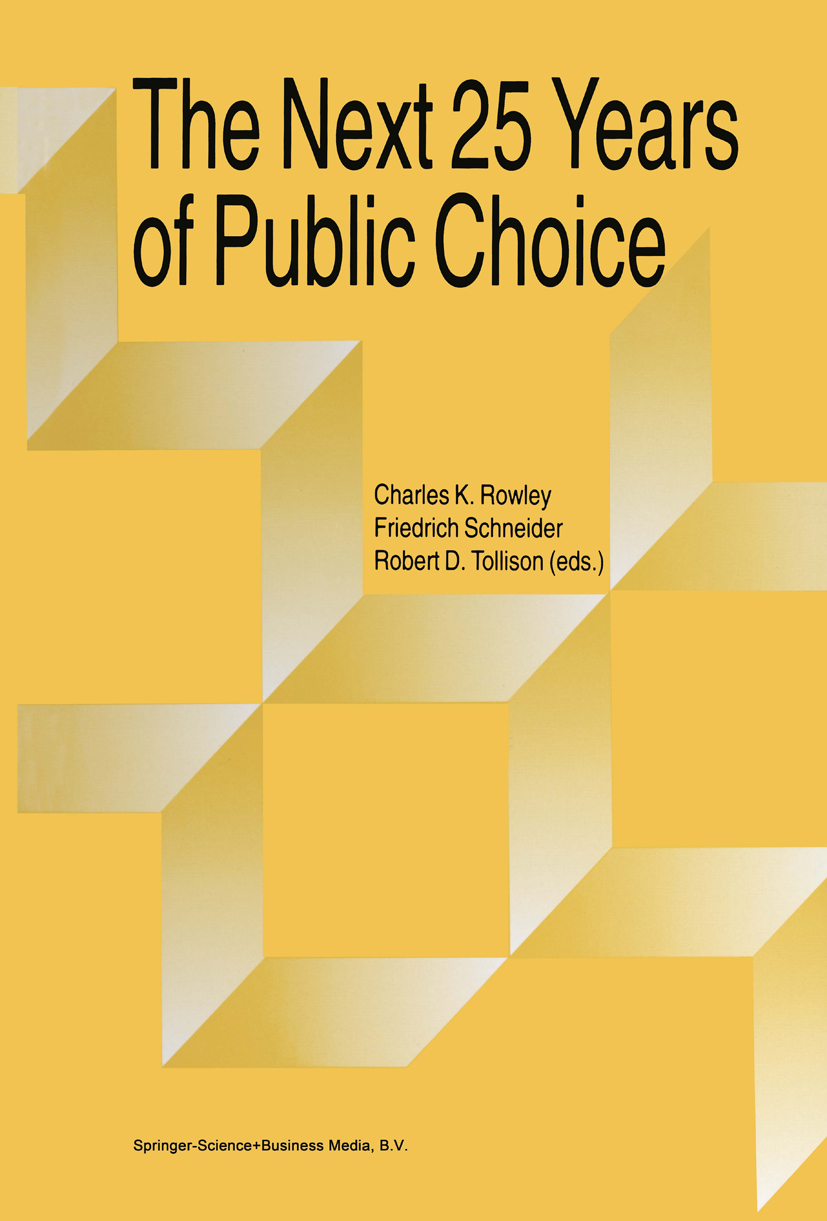
The Next Twenty-five Years of Public Choice The Next 25 Years of Public Choice brings together the perspectives of many of the world's leading scholars of public choice on the present state of knowledge and the likely future course of scholarship on public choice and constitutional economy. This book presents material in a manner accessible to a wide educated readership and will be influential in guiding future research in this important field. It is directed at professional scholars of public choice, economics and political science, government officials, graduate students and anyone seriously interested in public policy. A distinguished group of internationally well-known scholars offer their own often far-reaching views on strengths and weaknesses in the current literature and pinpoint important avenues of research amenable to future research. POLITICAL SCIENCE,General

Turkey and the European Community Nearly 29 years have passed since the EC and Thrkey forged the Association Agreement on 12.3.63. After abrief period on hold, Thrkish-EC relations regained dynamism when Thrkey applied for full membership on April 14, 1987. The view of the EC Commission, as presented some two and a half years later to the Council of Ministers, was approved by EC Foreign Ministers. The response stated that the EC would not start negotiations for membership until the completion of the Single Market. The main points of the Commission's observation focused on the discrepancy in the levels of economic development between Turkey and the EC, the issue of human rights, shortcomings in social security and the question of Cyprus. This response was a source of great disappoinment in Thrkey; because it had been a consistent ally of the West until then, taken important steps towards democracy and a free-market economy, EC membership, as Thrkey saw it, was to be its reward. POLITICAL SCIENCE,General
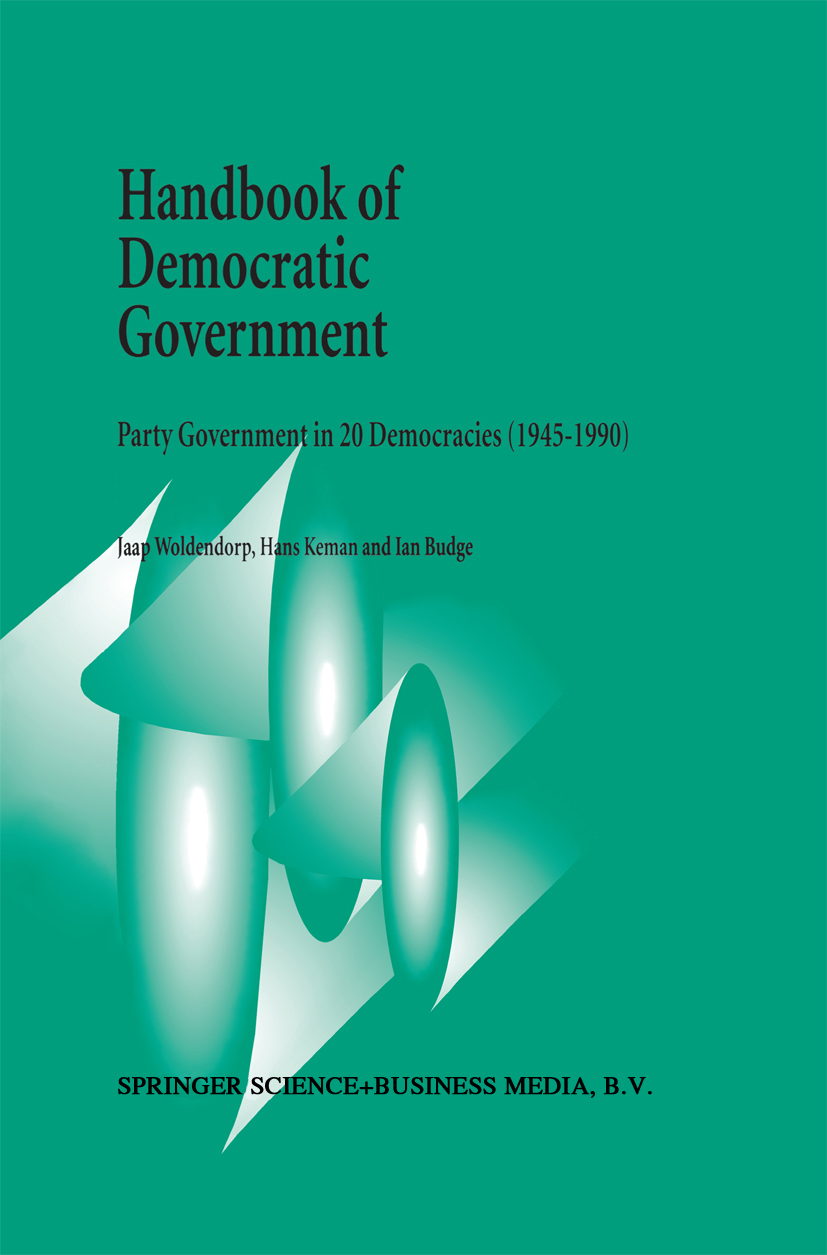
Handbook of Democratic Government The Handbook of Democratic Government is the first compact and comprehensive data collection for 20 countries which simultaneously provides comparative and complete information on the composition of governments. Parties, ministries, portfolios, ministers and parliamentary support are listed, as well as duration, type of government and reasons for termination. The data are organised in such a manner that every researcher can use them as a basic data set, ready to be transformed according to the particular needs dictated by the research undertaken. Various levels of analysis are possible, both cross-nationally and across time, ranging from individual ministers and separate ministries to specific parties, governments or countries. Given its format, the data set is also a very useful background to the special annual issue of the European Journal of Political Research: Political Data Yearbook. It will save researchers in the field of comparative politics valuable time as it can be utilised in connection with, or in addition to other data sources. POLITICAL SCIENCE,General
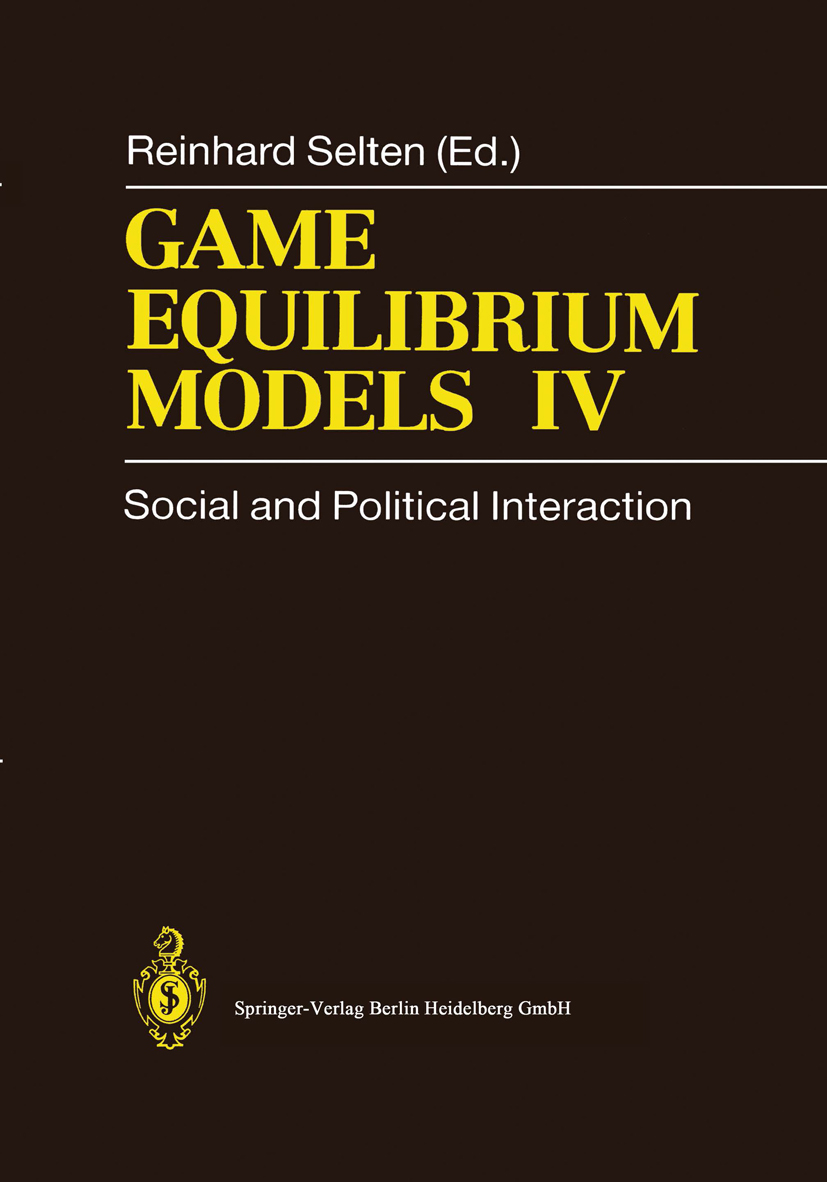
Game Equilibrium Models IV The four volumes of Game Equilibrium Models present applications of non-cooperative game theory. Problems of strategic interaction arising in biology, economics, political science and the social sciences in general are treated in 42 papers on a wide variety of subjects. Internationally known authors with backgrounds in various disciplines have contributed original research. The reader finds innovative modelling combined with advanced methods of analysis. The four volumes are the outcome of a research year at the Center for Interdisciplinary Studies of the University of Bielefeld. The close interaction of an international interdisciplinary group of researchers has produced an unusual collection of remarkable results of great interest for everybody who wants to be informed on the scope, potential, and future direction of work in applied game theory. Volume IV Social and Political Interaction contains game equilibrium models focussing on social and political interaction within communities or states or between states, i.e. national and international social and political interaction. Specific aspects of those interactions are modelled as non-cooperative games and their equilibria are analysed. POLITICAL SCIENCE,General

Challenges to American National Security in the 1990s The decade of the 1990s offers a chance to build a new and better international order. What policy choices will this decade pose for the United States? This wide-ranging volume of essays imaginatively addresses these crucial issues. The peaceful revolutions of 1989-1990 in the Soviet Union and Eastern Europe have swept away the foundations of the Cold War. The Eastern European nations are free; Europe is no longer divided; Germany is united. The Soviet threat to Western Europe is ending with the collapse of the Warsaw Pact and the withdrawals and asymmetrical cuts of Soviet forces. And U.S.-Soviet rivalry in the Third World is giving way to cooperation in handling conflicts, as in Iraq and elsewhere. Much, of course, remains uncertain and unsettled. What sort of Soviet Union will emerge from the ongoing turmoil, with what political and economic system and what state structure? How far and how soon will the Eastern Euro pean states succeed in developing pluralist democracies and market economies? Are the changes irreversible? Certainly there will be turmoil, backsliding, and failures, but a return to the Cold War hardly seems likely. POLITICAL SCIENCE,General
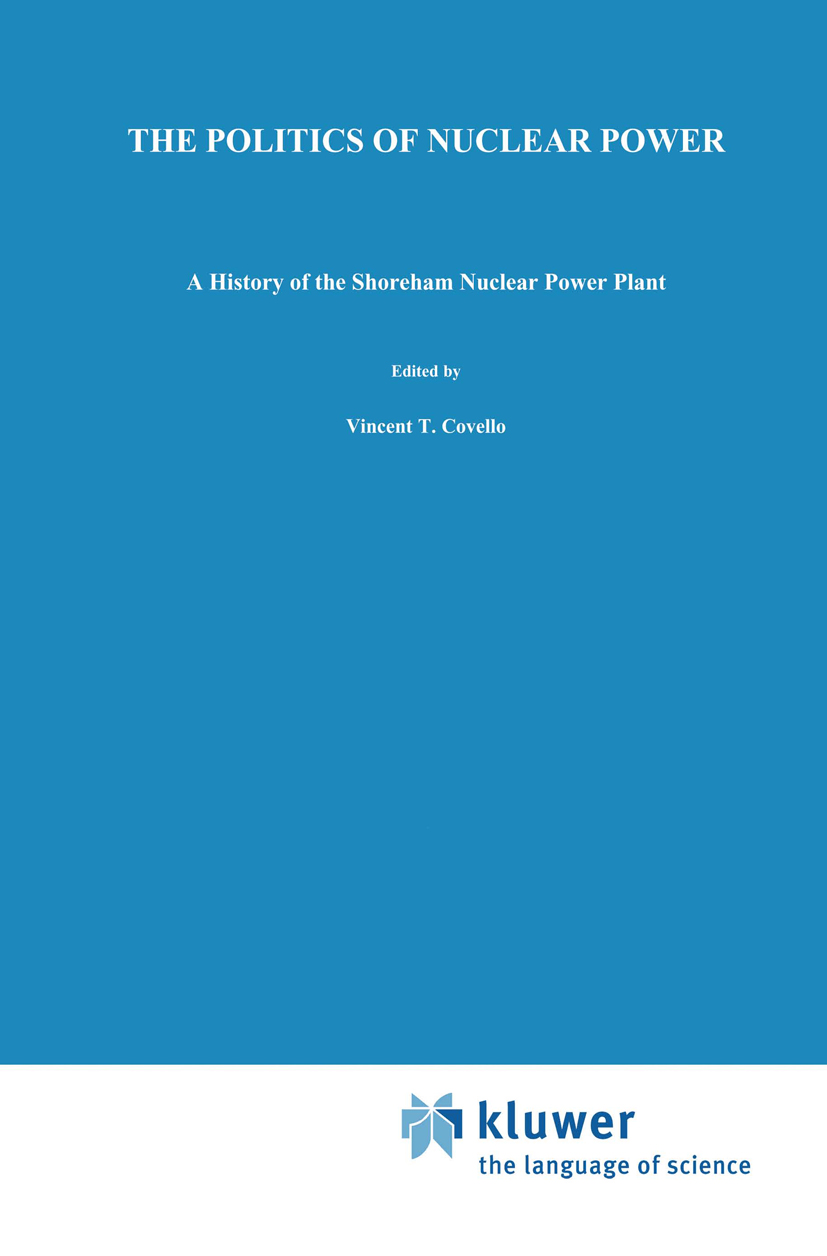
The Politics of Nuclear Power Several individuals noted the potentially important civilian uses of atomic energy shortly after the bombings of Hiroshima and Nagasaki in 1945. That year J. Robert Oppenheimer told a national radio audience that "in the near future" it would be possible to generate profitable electric power from "controlled nuclear chain reaction units" (reactors). It was suggested that, after fIfteen to twenty-five years of development, mature nuclear technology could provide virtually inexhaustible, cheap energy given the abundance of nuclear fuel. Admiral Lewis Strauss, the Chairman of the Atomic Energy Commission, stated that atomic power would generate electricity "too cheap to meter" (A statement that, according to Brookhaven National Laboratories' physicist Herbert Kouts, immediately "caused consternation among his technical advisors" [Kouts, 1983: 3)). For a brief period it was thought that airplanes would fly using atomic power, and homes would install small nuclear reactors for heat and hot water. 1950s and early 1960s a small number of prototype nuclear In the reactors came on line in the United States. The first power plant protoype reactor began operation in Shippingport, Pennsylvania in 1957. It was followed by the Dresden 1 unit near Chicago in 1959, the Yankee plant in Rowe, Massachusetts (1960), and the Indian Point (New York) and Big Rock Point (Michigan) plants in 1%2. These five plants had a combined 800 megawatts (800 MW), or less than one generating capacity ofless than percent of the total American electricity generating capacity in 1962. POLITICAL SCIENCE,General
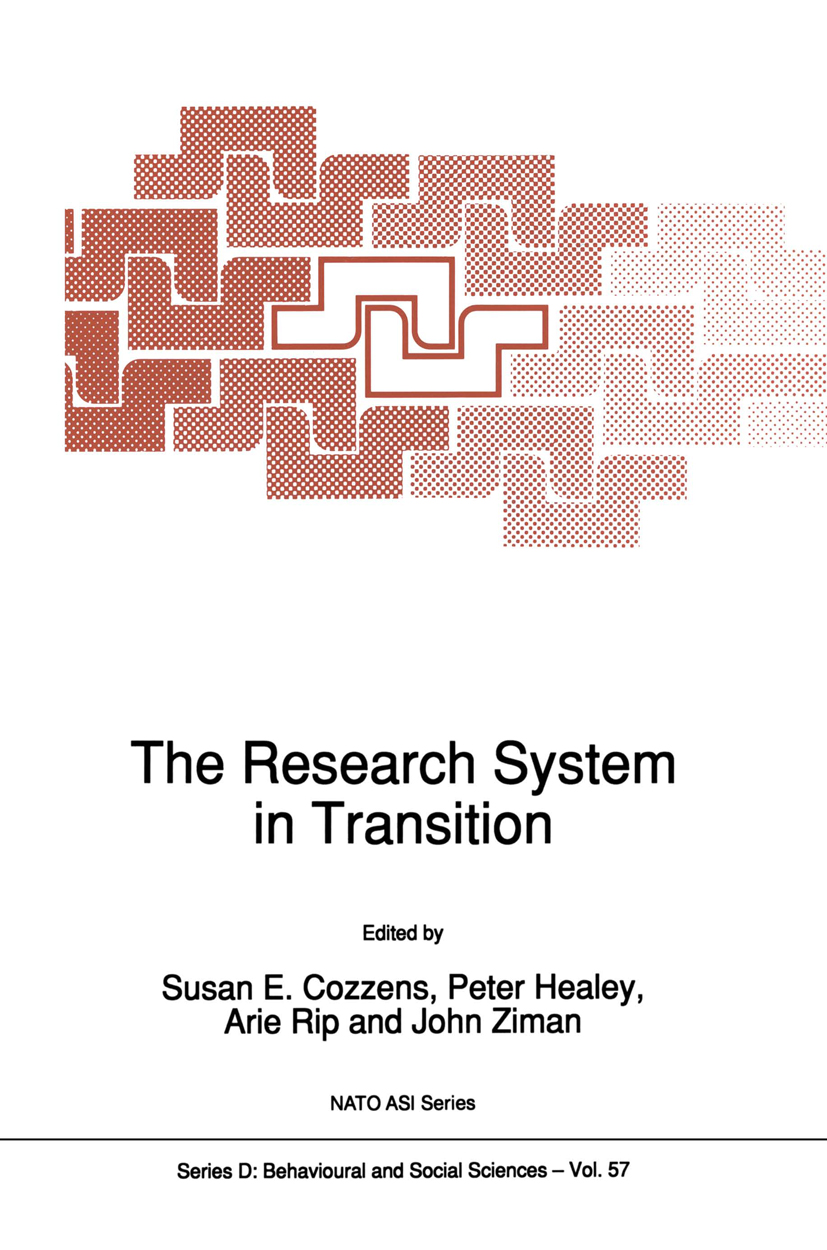
The Research System in Transition Proceedings of the NATO Advanced Study Institute on Managing Science in the Steady State: The Research System in Transition, Il Ciocco, Italy, October 1-13, 1989 POLITICAL SCIENCE,General
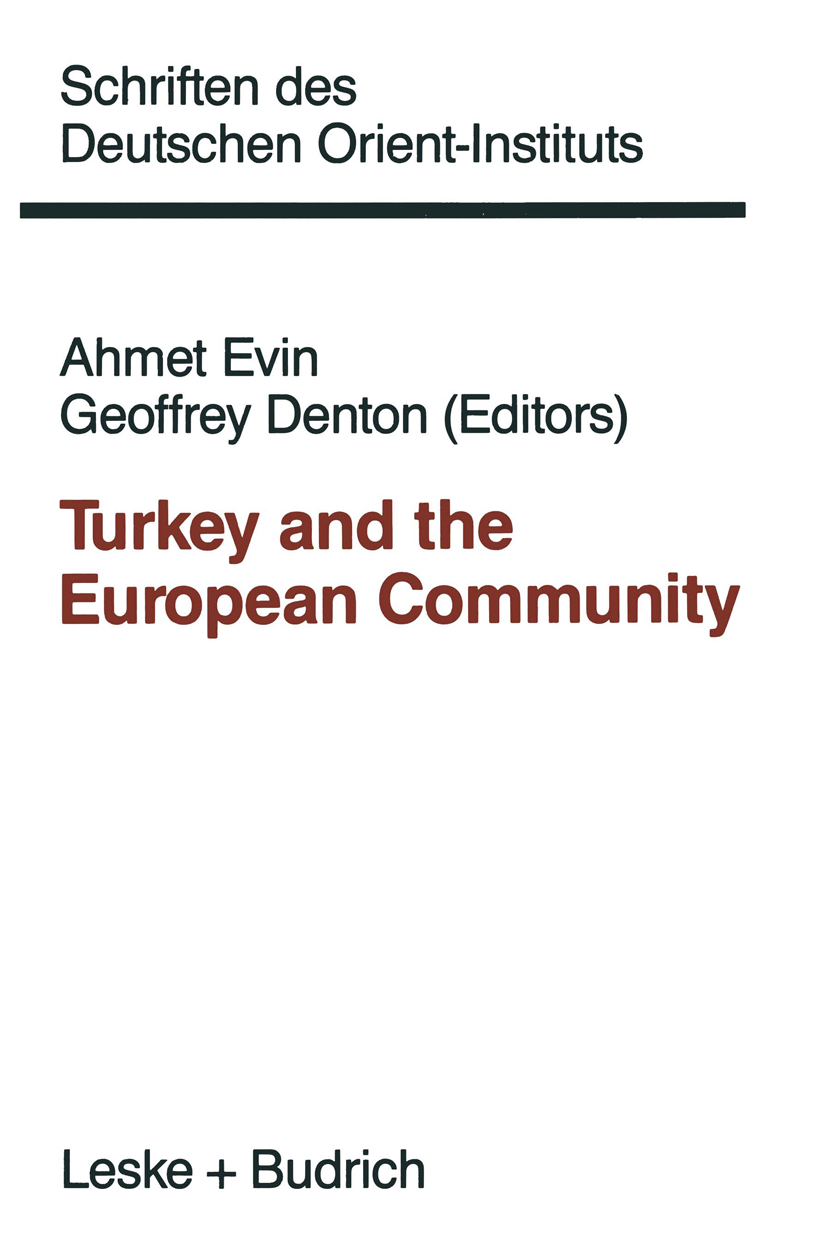
Turkey and the European Community The history of relations between the Europan Community and Thrkey has been a sad story, on both sides. Unrealism has been the keynote throughout. What was long overdue by the end of 1987 was to sweep away the past contradictions and tergiversations, and try to make a new start on a more realistic basis. Thrkey has now applied formally to resume as a full member of the Community. How ever, as several chapters of this Report show, there are on both sides great reservations a bout membership, unless this were intended to take place only many years ahead. Political ly, the relationship between the Community and Turkey was damaged by the Cyprus and Aegean problems between Thrkey and Greece. It began to break down already in 1964, and the breach was widened by the events of 1974 in Cyprus, by Greece's ·subsequent rapid ac cession to the Community, and by the military take over in Thrkey in 1980. Since 1980 there has been a slow process of restoration of relations, marked by new elections in November 1983, and a gradual rehabilitation of Turkey's position in the Council of Europe by 1986, as Turkey strove to re-establish its credentials as a democratic state. Economically there were serious complaints on both sides about the working of the As sociation Agreement. In the Community it was feit that the economic policy of Thrkish go vernments prior to 1979 was in contradiction with the purposes of the Agreement. POLITICAL SCIENCE,General
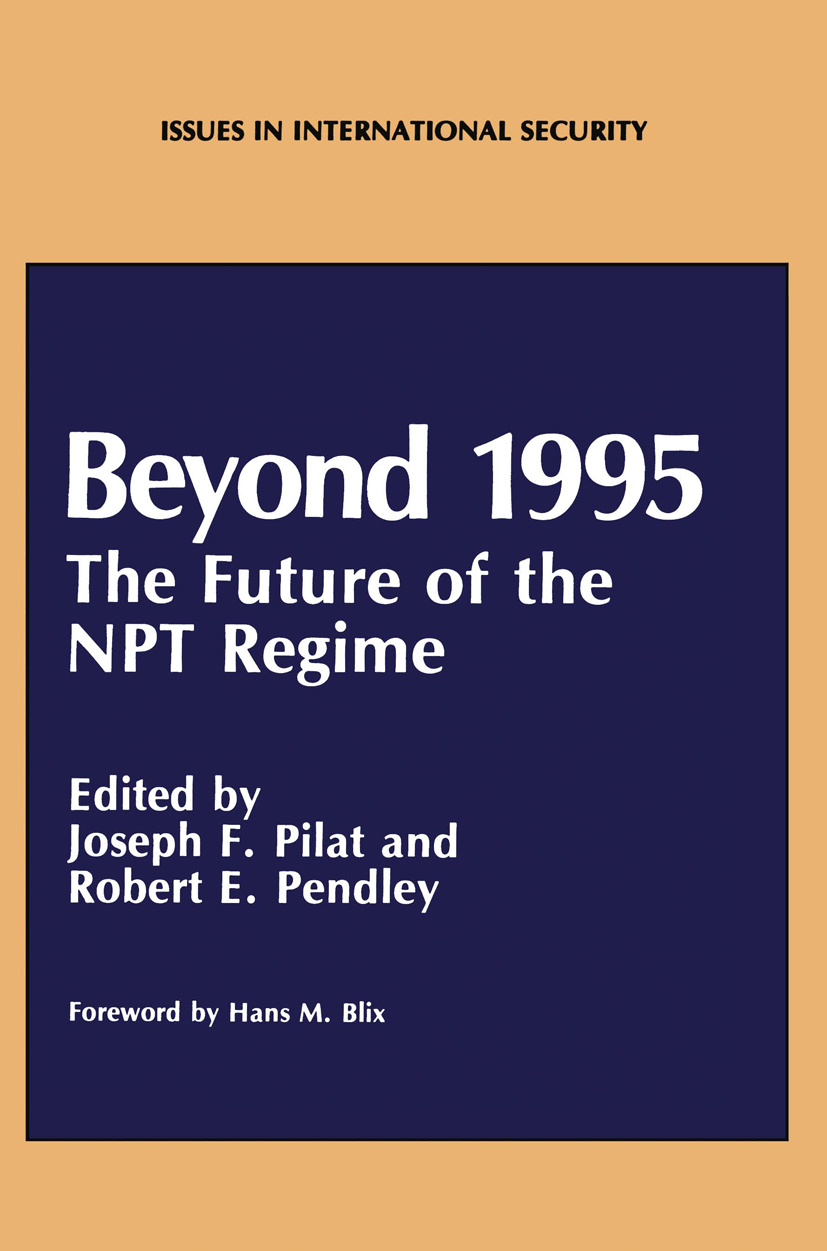
Beyond 1995 There is almost universal support for the view that the world would be an even more dangerous place if there were to be more nuclear-weapon states. There would be more fingers on more triggers and, probably, a greater risk that a trigger might be pulled with incalculable consequences. It is easy to see, therefore, that there is a collective interest in avoiding the spread of nuclear weapons to further countries. Nations do not, however, normally undertake or refrain from actions because of such a collective interest; they do so because of their individual interests. This is especially true in the field of national security. A nation perceiving that it has a real interest in developing nuclear weapons is not very likely to refrain from doing so merely because it is told such development would be bad for the world community. If the global interest in avoiding the spread of nuclear weapons to more coun tries is to succeed, conditions that make it in the interest of each individual nation to renounce nuclear weapons need to be created or maintained. Fortunately, conditions have prevailed in which the vast majority of nations have seen an advantage in making legally binding nonproliferation commitments. An important rationale for many of these countries has been that these commitments would facilitate the transfer of desired civil nuclear technology. POLITICAL SCIENCE,General
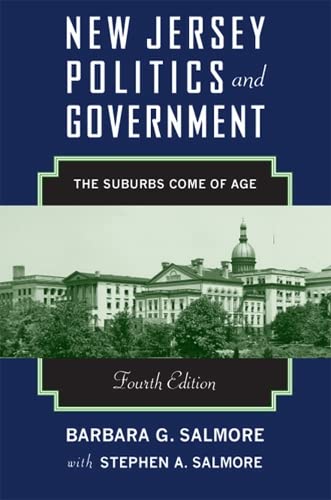
New Jersey Politics and Government This fourth edition is thoroughly updated to reflect the challenges New Jersey has overcome and those it continues to face: sustaining growth and opportunity in a multicultural society, providing quality education, and protecting the environment. State politics and government have been almost entirely reshaped in recent decades, and those changes are analyzed in every chapter of this edition. Offering a comprehensive overview of New Jersey politics and government, chapters cover the state’s political history; campaigns and elections; interest groups; the constitution; the development of government institutions; relationships with neighboring states, the federal government, and its own municipalities and counties; tax and spending policies; education; and quality of life issues. POLITICAL SCIENCE,General

Warlords Rising As non-state armed groups gain greater access to resources and networks through global interconnectivity, they have come to dominate the terrain of illegal trade in drugs, guns, and humans. Warlords Rising arms those confronting the mounting non-state challenge by delivering an innovative, interdisciplinary framework of analysis designed to improve understanding of non-state adversaries in order to affect their development and performance. POLITICAL SCIENCE,General

The United States and Great Power Responsibility in International Society This book evaluates American foreign policy actions from the perspective of great power responsibility, with three case studies: Operation Iraqi Freedom, American drone strikes in Pakistan and the post- 9/11 practice of extraordinary rendition. This book argues that the US invasion of Iraq in 2003, American drone attacks in Pakistan and the practice of extraordinary rendition are the examples of irresponsible actions undertaken by the U.S. acting as a great power in international society. Focusing on a major theoretical approach of International Relations, the English School, this book considers the responsibilities of great powers in international society. It points to three obligations of great powers: to act according to the norm of legality, to act according to the norm of legitimacy, and to adhere to the principles of prudence. The author applies the criteria of legality, legitimacy and prudence, to analyse the three foreign policy endeavours of the U.S., and, developing a normative framework, clarifies the implications for future U.S. foreign policy. This book will be of strong interest to students and scholars of international relations, international relations theory, American politics, foreign policy studies, international law, South Asian studies and Middle Eastern studies. POLITICAL SCIENCE,General

Multiple Paths to Knowledge in International Relations Multiple Paths to Knowledge in International Relations provides a uniquely valuable view of current approaches and findings in conflict studies. While expanding our knowledge of particular conflicts, from the Crimean War to the Vietnam War to ongoing Palestinian-Israeli instability, the notable contributors also further our understanding of how to conduct research in international relations. POLITICAL SCIENCE,General
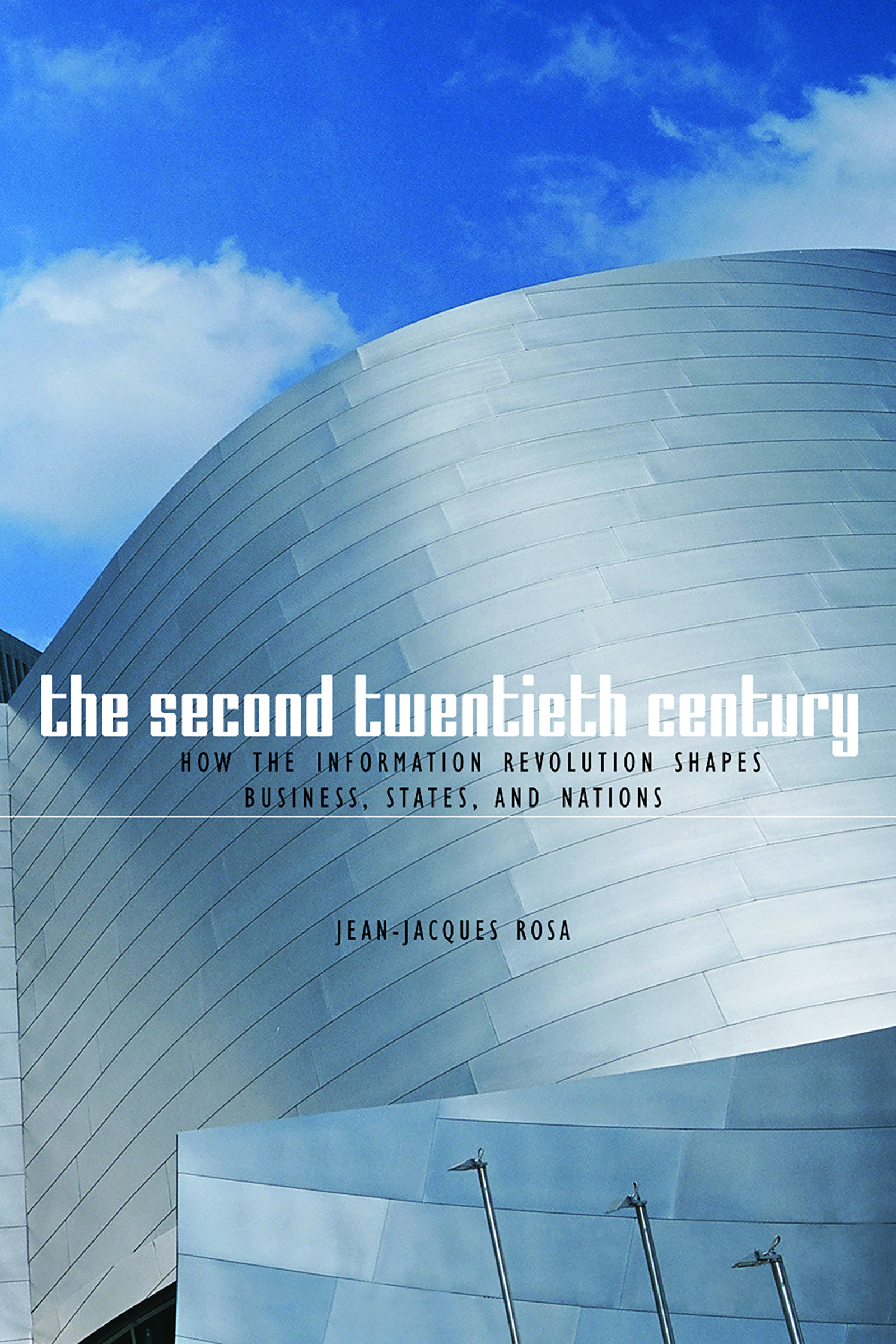
The Second Twentieth Century Jean-Jacques Rosa offers an analysis of the "grand cycle" in social organization of the twentieth century, showing how the transformation in communication and information technology has led to the downfall of the old political and corporate hierarchies. He explains how today's explosion of freely available information is fueling the democratic free-market revolution and reveals its universal contemporary consequences. POLITICAL SCIENCE,General
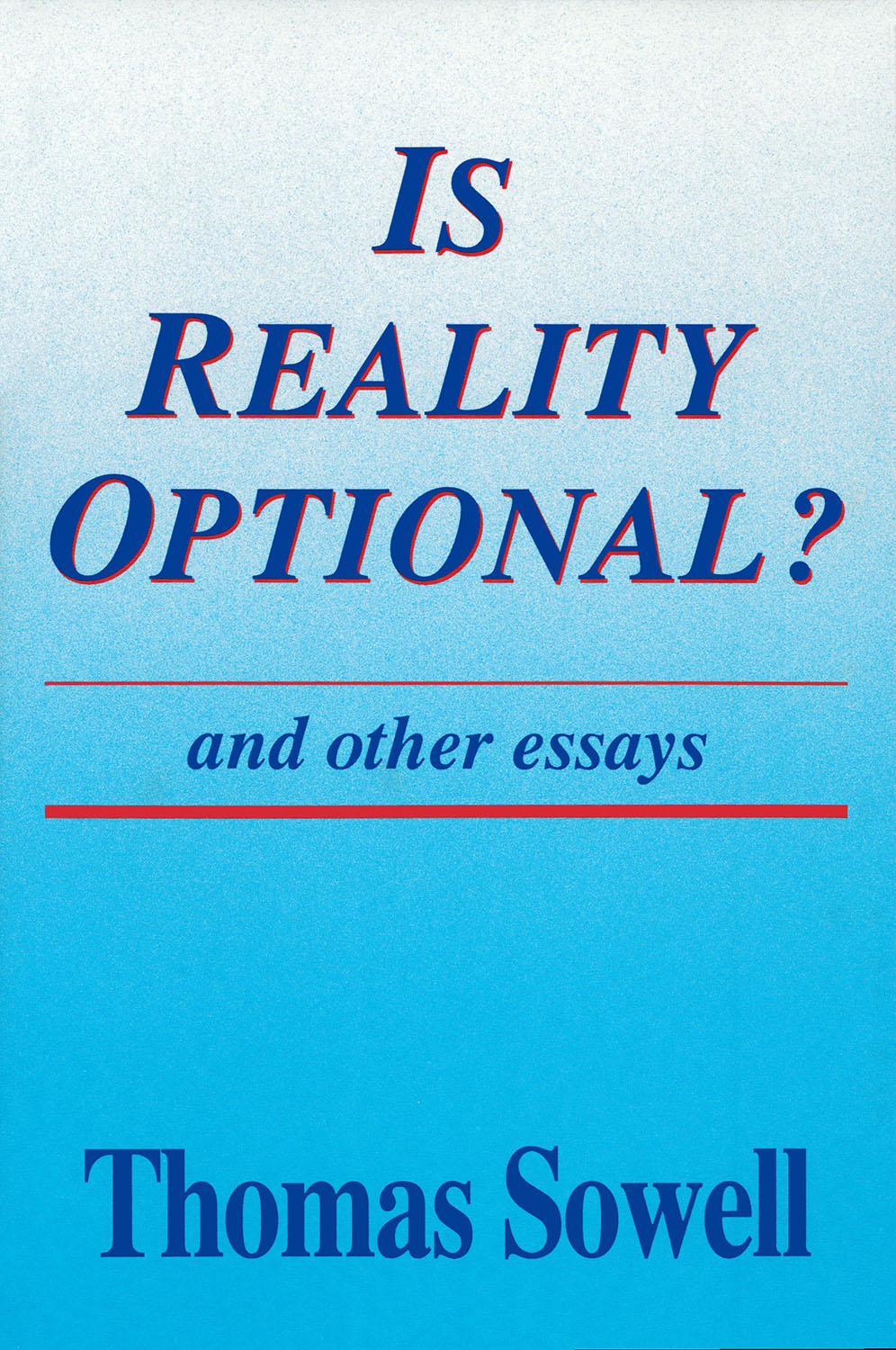
Is Reality Optional? Sowell challenges all the assumptions of contemporary liberalism on issues ranging from the economy to race to education in this collection of controversial essays, and captures his thoughts on politics, race, and common sense with a section at the end for thought-provoking quotes. POLITICAL SCIENCE,General

More Liberty Means Less Government In this collection of thoughtful, hard-hitting essays, Walter E. Williams once again takes on the left wing's most sacred cows with provocative insights, brutal candor, and an uncompromising reverence for personal liberty and the principles laid out in our Declaration of Independence and Constitution. POLITICAL SCIENCE,General
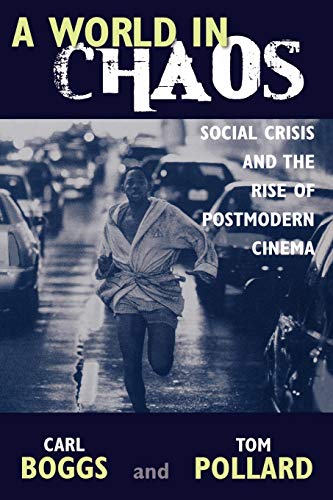
A World in Chaos Through an analysis of films such as American Beauty, Blade Runner, Natural Born Killers, and Thelma and Louise, Carl Boggs and Thomas Pollard explore the historical and theoretical shift from the long era of modernity to an emergent postmodernity and examine its intersection with film culture. POLITICAL SCIENCE,General

The Price of Power Price of Power examines Henry Kissinger’s influence on the development of the foreign policy of the United States during the presidency of Richard Nixon. POLITICAL SCIENCE,General
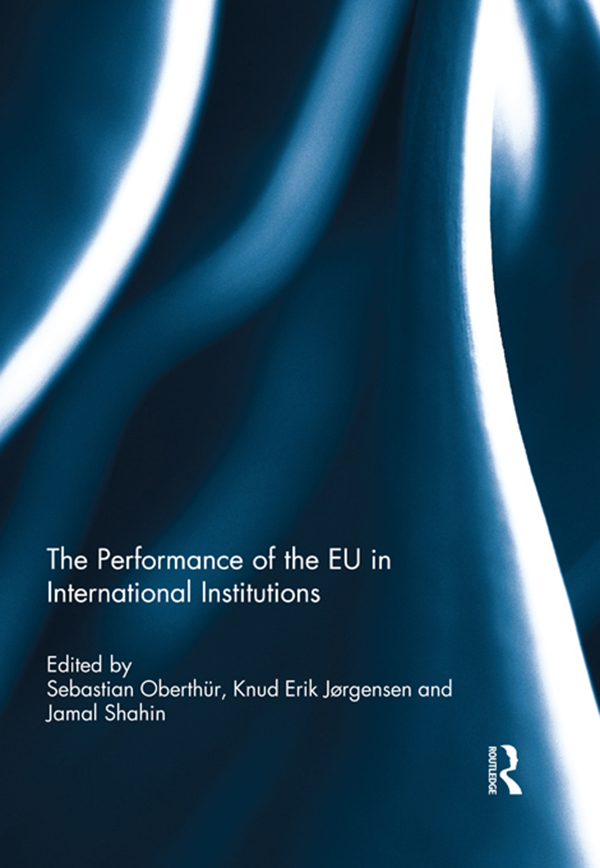
The Performance of the EU in International Institutions The Performance of the EU in International Institutions marks one of the first attempts to systematically analyse the subject. It focuses on the role of the EU in decision-making within international organizations and regimes as a major locus of global governance. The book unpacks the concept of EU performance into four core elements: effectiveness (goal achievement); efficiency (ratio between outputs accomplished and costs incurred); relevance (of the EU for its priority stakeholders); and financial/resource viability (the ability of the performing organization to raise the funds required). Based on the case studies herein, the findings presented in this book relate to the identified core elements of performance with a particular emphasis on the dimensions of 'effectiveness' and 'relevance'. Most notably, the EU appears, on balance and over the past two decades, to have become much more relevant for its member states when acting within international institutions. The book highlights four particular factors explaining EU performance in international institutions: the status of relevant EU legislation and policies, the legal framework conditions including the relevant changes that the Lisbon Treaty has brought about, domestic EU politics, and the international context. This book was originally published as a special issue of the Journal of European Integration POLITICAL SCIENCE,General
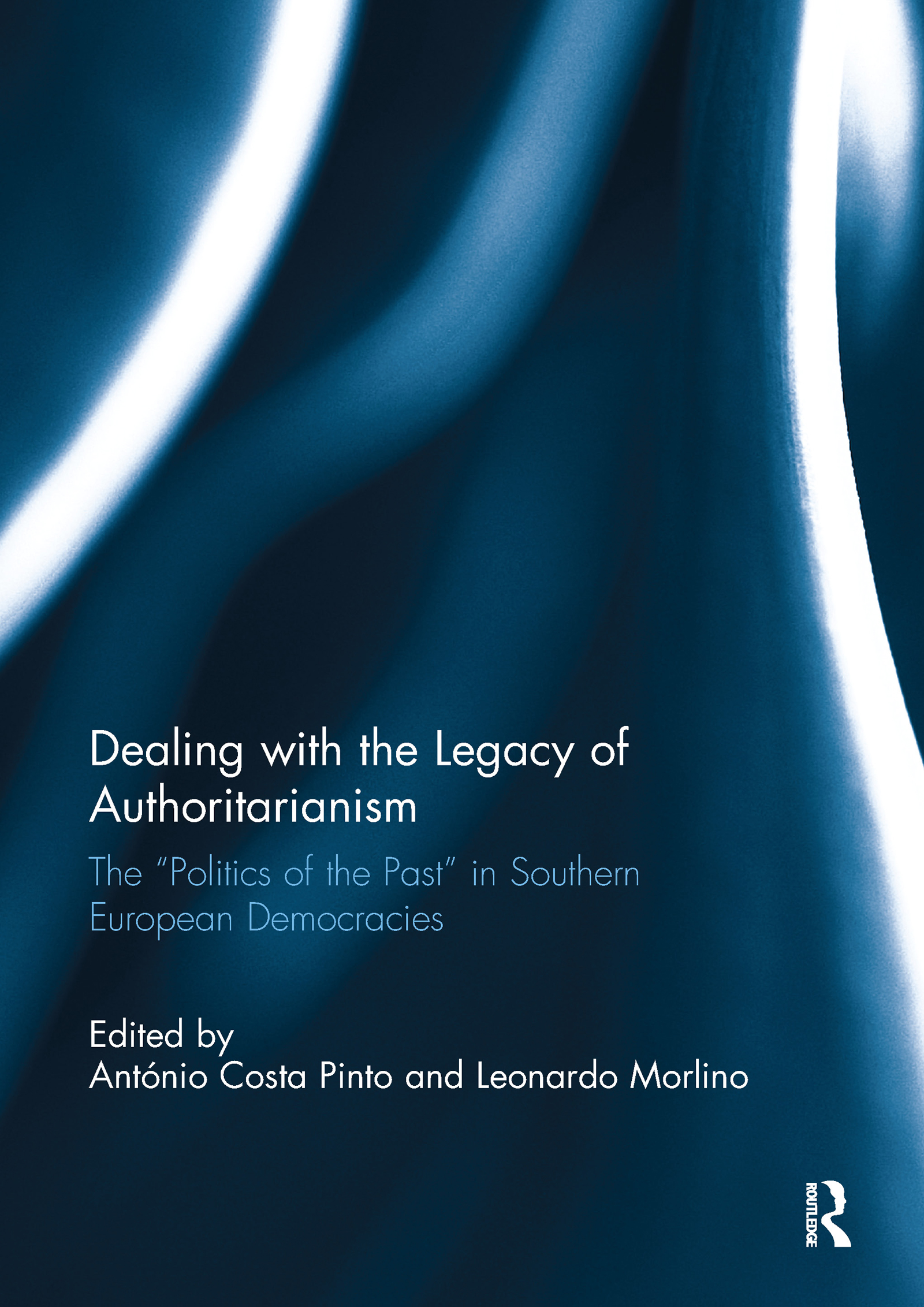
Dealing with the Legacy of Authoritarianism In recent years the agenda of how to ‘deal with the past’ has become a central dimension of the quality of contemporary democracies. Many years after the process of authoritarian breakdown, consolidated democracies revisit the past either symbolically or to punish the elites associated with the previous authoritarian regimes. New factors, like international environment, conditionality, party cleavages, memory cycles and commemorations or politics of apologies, do sometimes bring the past back into the political arena. This book addresses such themes by dealing with two dimensions of authoritarian legacies in Southern European democracies: repressive institutions and human rights abuses. The thrust of this book is that we should view transitional justice as part of a broader ‘politics of the past’: an ongoing process in which elites and society under democratic rule revise the meaning of the past in terms of what they hope to achieve in the present. This book was published as a special issue of South European Society and Politics. POLITICAL SCIENCE,General

Party Politics in the Western Balkans This book examines the development of party politics in the region of Western Balkans, describing party politics and analyzing inter-ethnic or inter-party cooperation and competition. Beginning with a thematic overview of the electoral systems and their link to the party systems, the authors consider the legacy of socialist/communist parties; compare the nationalist parties in the region; and explore opportunities for the national minorities. The book then provides detailed country case studies on Croatia, Bosnia and Herzegovina, Serbia, Montenegro, Kosovo, Macedonia and Albania that: Provide an overview of the development of the respective political system since 1990, presenting key changes over time Depict important political issues in each of these countries and explains parties´ particular policies in relation to these issues Discuss the level of democracy as well as ethnic minorities in the given states Explore the extent to which nationalism has dominated party organization, the stability of the parties, important changes in the party policies, and their electoral performance and personalisation of the parties Bringing together a range of specialist experts on the Balkans, this book will be of interest to students and scholars of party politics, comparative European politics, post-communist politics, nationalism, Southern European and Western Balkan politics. POLITICAL SCIENCE,General
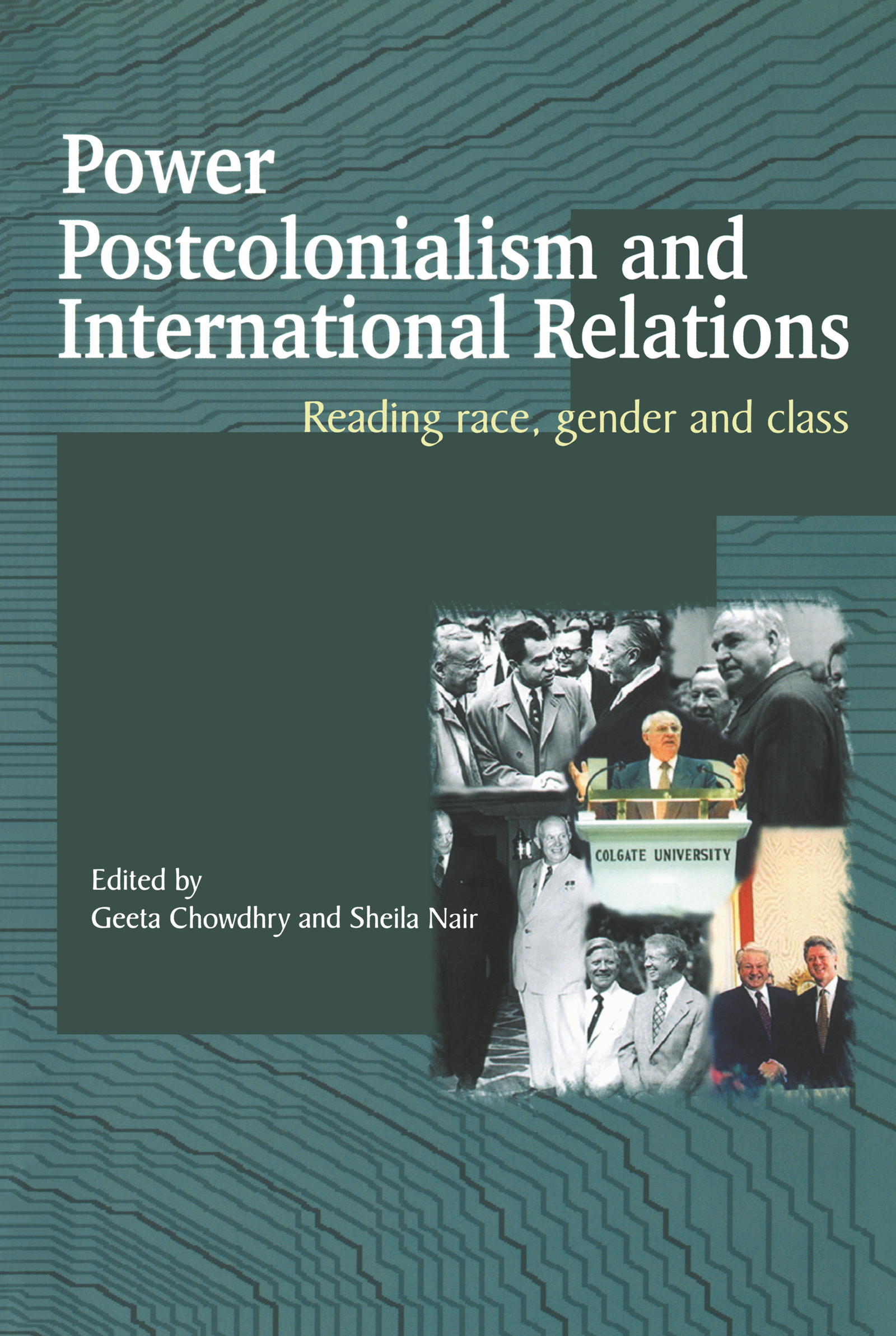
Power, Postcolonialism and International Relations "Chowdhry and Nair, along with the authors of this volume, make a timely, vital, and deeply necessary intervention in international relations - one that informs theoretically, enriches our knowledge of the world through its narratives, and forces us to confront the differentiated wholeness of our humanity. Readers will want to emulate the skills and sensibilities they offer.."Naeem Inayatullah, Ithaca College This work uses postcolonial theory to examine the implications of race, class and gender relations for the structuring or world politics. It addresses further themes central to postcolonial theory, such as the impact of representation on power relations, the relationship between global capital and power and the space for resistance and agency in the context of global power asymmetries. POLITICAL SCIENCE,General
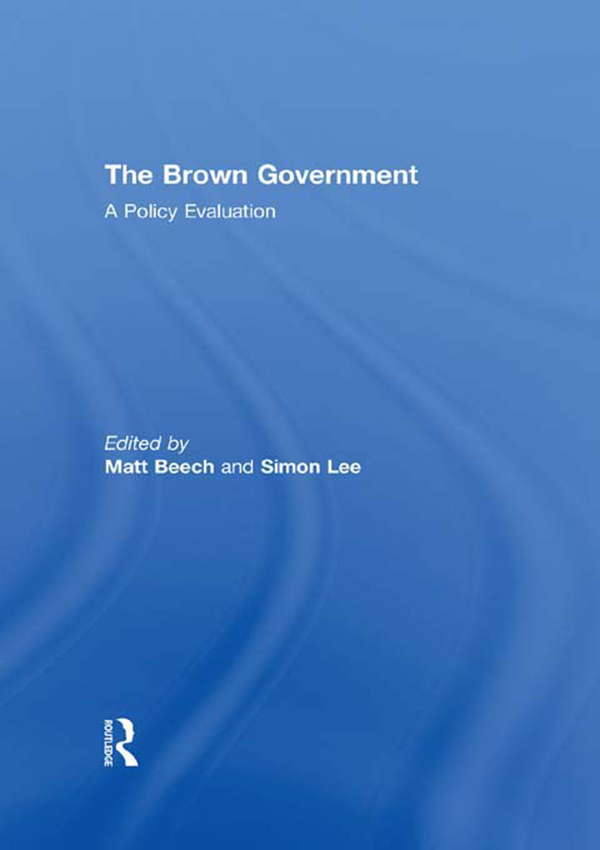
The Brown Government The Brown Government provides an interim evaluation of Gordon Brown’s Labour administration through identifying continuities and discontinuities with the Blair governments from 1997. By focusing on key ideas and areas of public policy it presents an analysis of the first 18 months of Brown’s government. This book is notable for its topicality particularly for the discussions of the credit crunch, the British banking crises and the interconnectedness of these events with the global economic downturn. A study of Brown’s handling of these crises in the economy is important as it is arguable that the present recession and credit crunch will reach unprecedented proportions and therefore define the character and content of British politics in the coming years. By conducting an examination of the Brown Government’s public policy priorities one can begin to decipher its aims and values and, by so doing, begin to understand the next phase of the New Labour project. In this sense the book is a contribution to the ongoing study of contemporary British social democracy. This book was published as a special issue of Policy Studies. POLITICAL SCIENCE,General
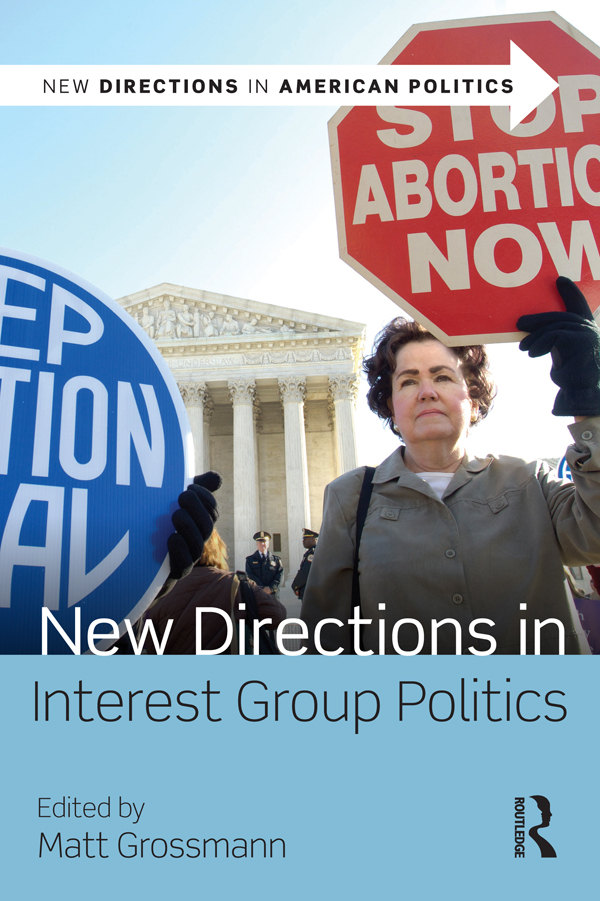
New Directions in Interest Group Politics Reflecting cutting edge scholarship but written for undergraduates, New Directions in Interest Group Politics will help students think critically about influence in the American political system. There is no shortage of fear about "the special interests" in American political debate, but reliable information about what interest groups do, who they represent, and how they influence government is often lacking. This volume, comprised of original essays by leading scholars, is designed to summarize and explain contemporary research that helps address popular questions and concerns, making studies accessible to undergraduate students and providing facts to butress informed debate. The book covers the mobilization of interest groups, their activities, and their influence. Each chapter briefly reviews research on a central question of scholarship before focusing on a particular empirical project designed to shed light on the topic. Rather than simply providing a descriptive overview, the chapters are designed to foster critical thinking by getting students to assess the role of interest groups in the American political system and supplying evidence of their effects. Importantly, a set of web resources associated with the book offer instructions for research and writing assignments. Students will be able to collect and analyze data on campaign finance, lobbying, and interest group involvement in governance. The eResource website includes materials for several classroom simulations, such as an interest group legislative battle, a Netroots convention, and a rule-making process. As they read about key questions in democratic government and current research trends, students can practice serving as interest group activists and conduct original research on topics that most interest them. POLITICAL SCIENCE,General

Elements of Law, Natural and Political First Published in 1969. Routledge is an imprint of Taylor & Francis, an informa company. POLITICAL SCIENCE,General

Negotiation Theory and the EU Negotiations are central to the ethos and functioning of the European Union, yet the dynamics of EU negotiations have received far too little systematic scholarly attention. This volume offers a thematic and forward-looking survey of cutting-edge research on EU negotiation dynamics, identifying findings to date and setting an empirical and methodological agenda for future research. The chapters by leading international experts address a wide range of critical questions in this area, including: What factors influence negotiation behaviour and outcomes in the EU? How can we explain variation in the choice of negotiation styles? When do actors engage in arguing or bargaining? What are the determinants of bargaining power? What are the institutional foundations of EU negotiations? And what role does the presidency play in EU negotiations? The volume also discusses how the findings of the multi-disciplinary field of ‘negotiation studies’ can inform research on negotiation dynamics in the EU. The volume will be of great interest to established scholars and advanced students of international relations, European integration and governance, and negotiation analysis. This book was based on a special issue of Journal of European Public Policy. POLITICAL SCIENCE,General
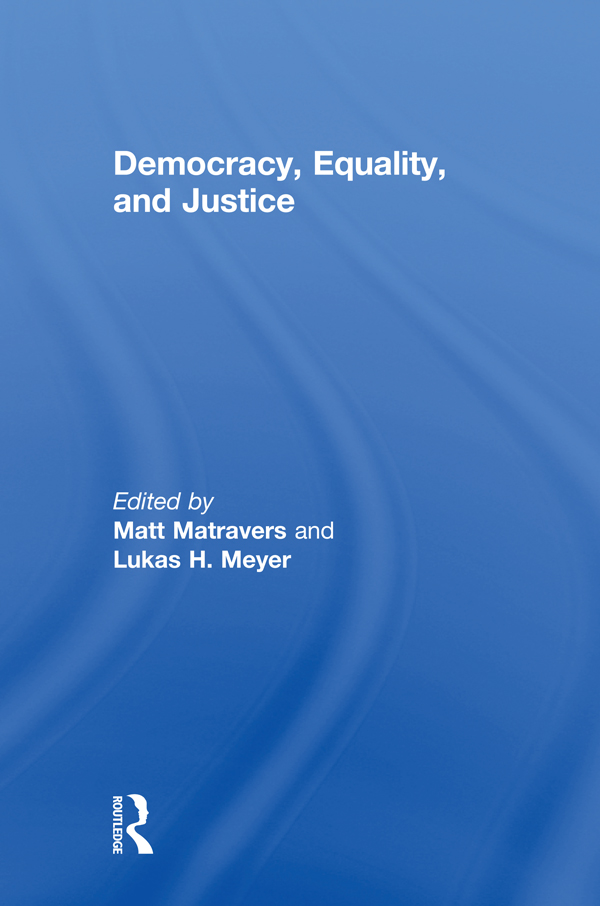
Democracy, Equality, and Justice In addressing democracy, equality, and justice together, the book stimulates discussions that go beyond the sometimes increasingly technical and increasingly discrete literatures that now dominate the study of each concept. The chapters fall into four categories: on justice and democracy; justice and equality; justice and community; and justice and the future. Concerns of justice unite all the chapters in this volume. However, these concerns now manifest themselves in interesting and new directions. Politically, the book confronts urgent problems of democracy, equality, community, and of how to respond to potentially catastrophic climate change. The response to these problems cannot only be pragmatic and piecemeal. What emerges are a number of interlinking questions and themes that together constitute the central core of contemporary political philosophy. This book was previously published as a special issue of the Critical Review of Social and Political Philosophy. POLITICAL SCIENCE,General

The Grand Titration First published in 1969. The historical civilization of China is, with the Indian and European-Semitic, one of the three greatest in the world, yet only relatively recently has any enquiry been begun into its achievements in science and technology. Between the first and fifteenth centuries the Chinese were generally far in advance of Europe and it was not until the scientific revolution of the Renaissance that Europe drew ahead. Throughout those fifteen centuries, and ever since, the West has been profoundly affected by the discoveries and invention emanating from China and East Asia. In this series of essays and lectures, Joseph Needham explores the mystery of China's early lead and Europe's later overtaking. POLITICAL SCIENCE,General

International Relations Theory The fourth edition of this innovative textbook introduces students to the main theories in international relations. It explains and analyzes each theory, allowing students to understand and critically engage with the myths and assumptions behind them. Each theory is illustrated using the example of a popular film. Key features of this textbook include: Discussion of all the main theories: realism and neo-realism, idealism and neo-idealism, liberalism, constructivism, postmodernism, gender, globalization, environmentalism, anarchism A new chapter on anarchism, debt and the Occupy Movement including use of the film, The Hunger Games New chapter brings the textbook up to date with reflections on the 2008 Global Financial Crisis and reactions to it by focusing on the myth this crisis generated, ‘We are the 99%’ Innovative use of narratives from films that students will be familiar with: Lord of the Flies, Independence Day, Wag the Dog, Fatal Attraction, The Truman Show, East is East, Memento, WALL-E and The Hunger Games Accessible and exciting writing style which is well-illustrated with film stills in each chapter, boxed key concepts and guides to further reading. This breakthrough textbook has been designed to unravel the complexities of international relations theory in a way that gives students a clearer idea of how the theories work, and of the myths associated with them. POLITICAL SCIENCE,General
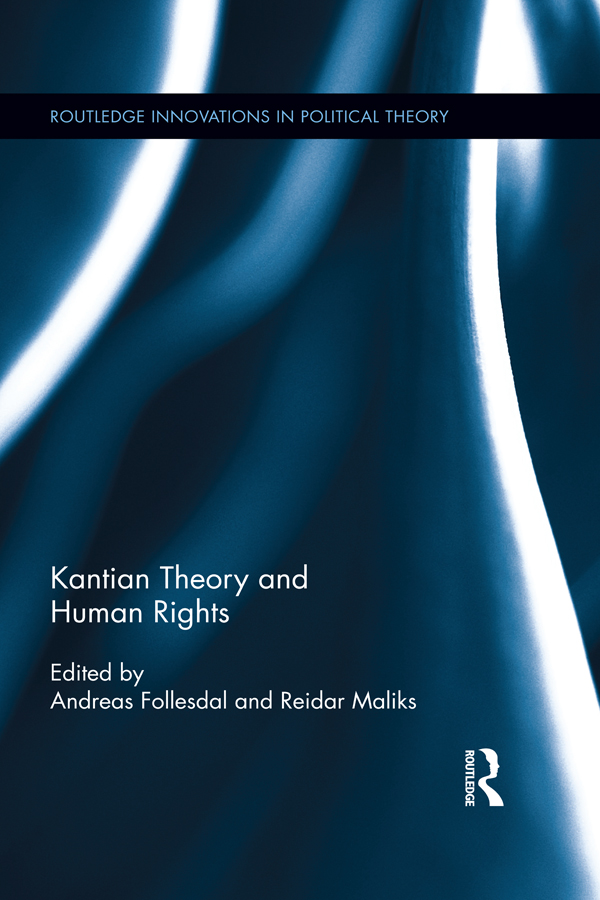
Kantian Theory and Human Rights Human rights and the courts and tribunals that protect them are increasingly part of our moral, legal, and political circumstances. The growing salience of human rights has recently brought the question of their philosophical foundation to the foreground. Theorists of human rights often assume that their ideal can be traced to the philosophy of Immanuel Kant and his view of humans as ends in themselves. Yet, few have attempted to explore exactly how human rights should be understood in a Kantian framework. The scholars in this book have gathered to fill this gap. At the center of Kant’s theory of rights is a view of freedom as independence from domination. The chapters explore the significance of this theory for the nature of human rights, their justification, and the legitimacy of international human rights courts. POLITICAL SCIENCE,General

The State This book offers a fresh, accessible and original interpretation of the modern state, concentrating particularly on the emergence and nature of democracy. Poggi presents an extensive conceptual portrait of the state, distinguishing its early characteristics from those which have developed subsequently and are apparent in contemporary states. He reviews the 'historical career' of the state, from the dissolution of feudal forms of rule to the advent of modern, liberal-democratic systems. Poggi also discusses the nature of liberal-democratic regimes, and the distinctive features of the Soviet one-party system. Finally, the chapter discusses the challenges set to the state by contemporary developments in military affairs, in the international economy, and in the ecological sphere. POLITICAL SCIENCE,General
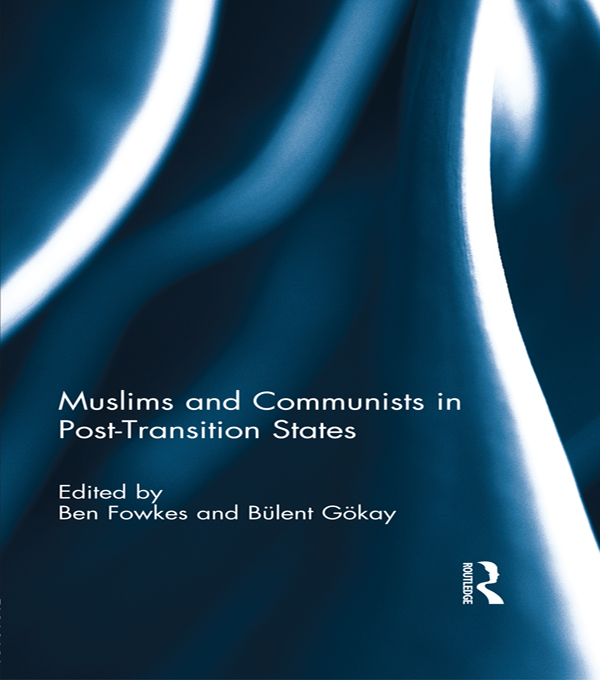
Muslims and Communists in Post-Transition States Popular uprisings have taken many different forms in the last hundred or so years since Muslims first began to grapple with modernity and to confront various systems of domination both European and indigenous.The relevance of studies of popular uprising and revolt in the Muslim world has recently been underlined by shattering recent events, particularly in Egypt, Yemen, Tunisia and Libya. The book consists of a close analysis of the problématique of the Qur’an, showing the openness of the text to Islamic reform and renewal; the role of Islam in creating a specific form of communism in Albania and Kosova; the Chechen revolts against Russian rule after the collapse of the Soviet Union, and the short-lived period of alliance between communism and Islam in the early 1920s; the history of alliances between British Muslims and socialists since the 1950s. The book also traces the evolution of the Muslim-Communist alliance during the twentieth century, analyses the driving forces behind it, looks at the new situation created by the democratic revolts of 2010-11 in the Middle East and attempts a prognosis for future relations between these and existing communist groups. This volume contributes to the debate over the aims and methods of these popular uprisings. This book was published as a special issue of the Journal of Communist Studies and Transition Politics. POLITICAL SCIENCE,General
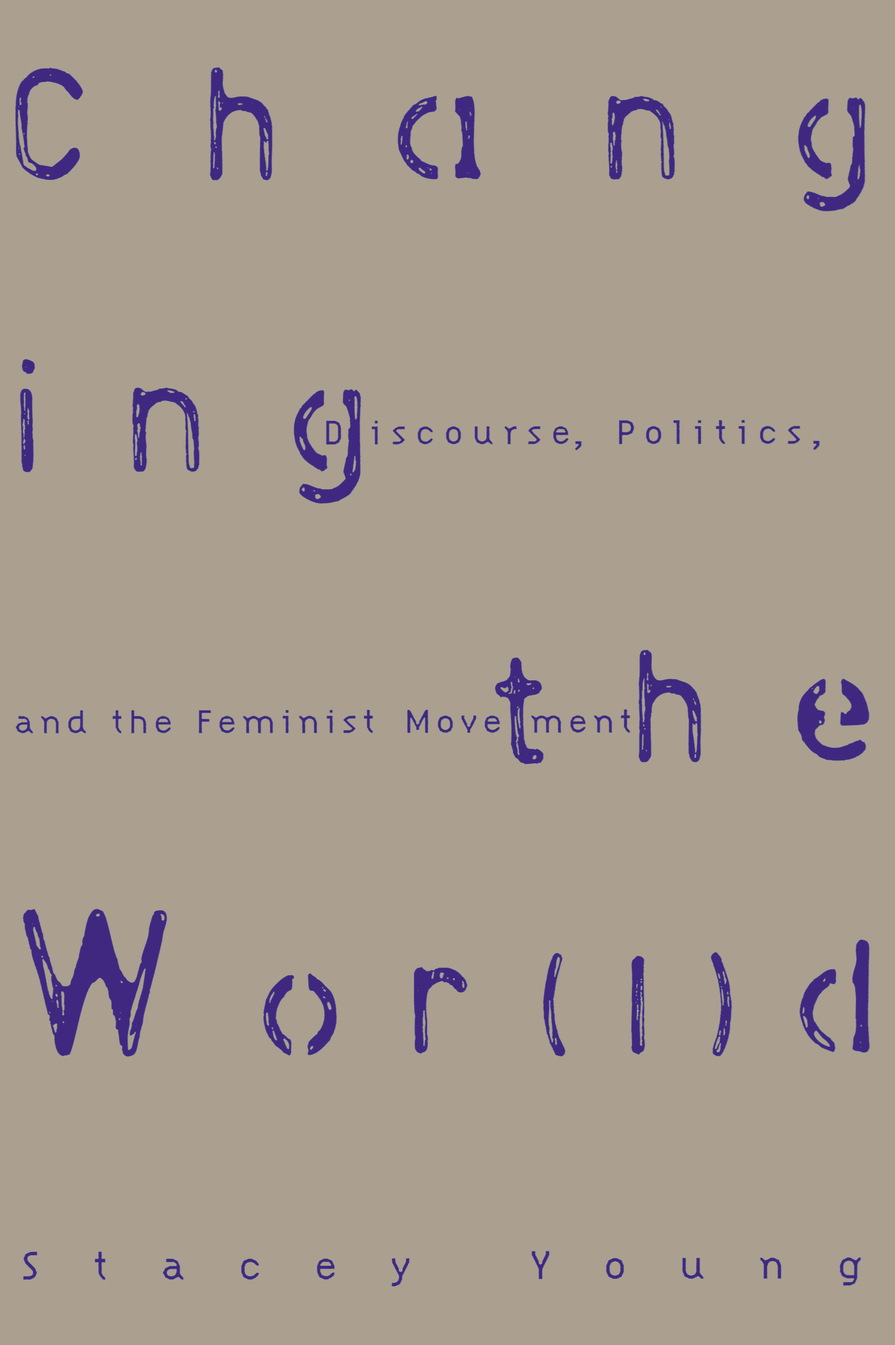
Changing the Wor(l)d Changing the Wor(l)d draws on feminist publishing, postmodern theory and feminist autobiography to powerfully critique both liberal feminism and scholarship on the women's movement, arguing that both ignore feminism's unique contributions to social analysis and politics. These contributions recognize the power of discourse, the diversity of women's experiences, and the importance of changing the world through changing consciousness. Young critiques social movement theory and five key studies of the women's movement, arguing that gender oppression can be understood only in relation to race, sexuality, class and ethnicity; and that feminist activism has always gone beyond the realm of public policy to emphasize improving women's circumstances through transforming discourse and consciousness. Young examines feminist discursive politics, critiques social science methodology, and proposes an alternative approach to understanding the women's movement. POLITICAL SCIENCE,General

Government Leaders, Military Rulers and Political Activists In each volume, an introductory essay outlines of history of the disciplines under discussion, and describes how changes and innovations in these disciplines have affected our lives. The biographies that follow are organized in an A-Z format: each biography is divided into a "life" section describing the individual's life and influences and a "legacy" section summarizing the impact of that individual's work throughout history. These biographies cover a diverse group of men and women from around the globe and throughout history. Franklin Delano Roosevelt, Mao Tse-tung and Genghis Khan are among the 200 well-known historical figures included in this volume. Examples of other lesser-known, yet important, individuals covered in this work are: Gustavas Adolphus, Swedish empire creator; Hatshepsut, queen of ancient Egyptian dynasty; and Jean Jaurès, French socialist leader and pacifist. Each synopsis provides information on each individual's enduring impact on the common understanding of fundamental themes of human existence. POLITICAL SCIENCE,General

On Rumors Many of us are being misled. Claiming to know dark secrets about public officials, hidden causes of the current economic situation, and nefarious plans and plots, those who spread rumors know precisely what they are doing. And in the era of social media and the Internet, they know a lot about how to manipulate the mechanics of false rumors—social cascades, group polarization, and biased assimilation. They also know that the presumed correctives—publishing balanced information, issuing corrections, and trusting the marketplace of ideas—do not always work. All of us are vulnerable. In On Rumors, Cass Sunstein uses examples from the real world and from behavioral studies to explain why certain rumors spread like wildfire, what their consequences are, and what we can do to avoid being misled. In a new afterword, he revisits his arguments in light of his time working in the Obama administration. POLITICAL SCIENCE,General

The Prince Often cited as one of the first works in modern political philosophy, The Prince is a political treatise that relates author Niccolo Machiavelli’s theories on state-building and rulership. Drawing on his experience as a diplomat, Machiavelli discusses the important policies for both republican free-states and hereditary princedoms, and outlines the most successful political tactics, many of which remain relevant into modern times. HarperTorch brings great works of non-fiction and the dramatic arts to life in digital format, upholding the highest standards in ebook production and celebrating reading in all its forms. Look for more titles in the HarperTorch collection to build your digital library. POLITICAL SCIENCE,General

The Crusader Based on extraordinary research: a major reassessment of Ronald Reagan's lifelong crusade to dismantle the Soviet Empire–including shocking revelations about the liberal American politician who tried to collude with USSR to counter Reagan's efforts Paul Kengor's God and Ronald Reagan made presidential historian Paul Kengor's name as one of the premier chroniclers of the life and career of the 40th president. Now, with The Crusader, Kengor returns with the one book about Reagan that has not been written: The story of his lifelong crusade against communism, and of his dogged–and ultimately triumphant–effort to overthrow the Soviet Union. Drawing upon reams of newly declassified presidential papers, as well as untapped Soviet media archives and new interviews with key players, Kengor traces Reagan's efforts to target the Soviet Union from his days as governor of California to the fall of the Berlin Wall and the collapse of what he famously dubbed the "Evil Empire." The result is a major revision and enhancement of what historians are only beginning to realize: That Reagan not only wished for the collapse of communism, but had a deep and specific understanding of what it would take––and effected dozens of policy shifts that brought the USSR to its heels within a decade of his presidency. The Crusader makes use of key sources from behind the Iron Curtain, including one key memo that implicates a major American liberal politician–still in office today–in a scheme to enlist Soviet premier Yuri Andropov to help defeat Reagan's 1984 reelection bid. Such new finds make The Crusader not just a work of extraordinary history, but a work of explosive revelation that will be debated as hotly in 2006 as Reagan's policies were in the 1980s. POLITICAL SCIENCE,General

Politics Ideas in Profile: Small Introductions to Big Topics In the first title of an exciting new series one of the world's leading political scientists asks the big questions about politics: what is it, why we do we need it and where, in these turbulent times, is it heading? From the gap between rich and poor to the impact of social media, via Machiavelli, Hobbes and Weber, Runciman's comprehensive short introduction is invaluable to those studying politics or those who want to know how life in Denmark became more comfortable than in Syria. The Ideas in Profile series is what introductions can and should be. Concise, clear, relevant, entertaining, original and global in scope, Politics makes essential reading for anyone, from students to the general reader. POLITICAL SCIENCE,General

The EU, Migration and the Politics of Administrative Detention Migration is now regarded as a security issue, both in public debate and government policies. In turn, the phenomenon of detention as a governance practice has emerged, and the developing presence of camps in Europe for migrants has given rise to a tangle of new and complex issues. This book examines the phenomenon of irregular immigration, and provides a comprehensive picture of the practices and the implications of detention of migrants within and the European Union. It analyses ‘detention’ as a tool of governance and in doing so explores several key themes: the security threat for Europe the security governance processes enacted to handle irregular immigration the forms of detention in different geographical contexts the effectiveness of the EU’s approach to the issue. The EU, Migration and the Politics of Administrative Detention will be of interest to students and scholars of the EU’s external relations, migration, human rights, European politics and security studies. POLITICAL SCIENCE,General
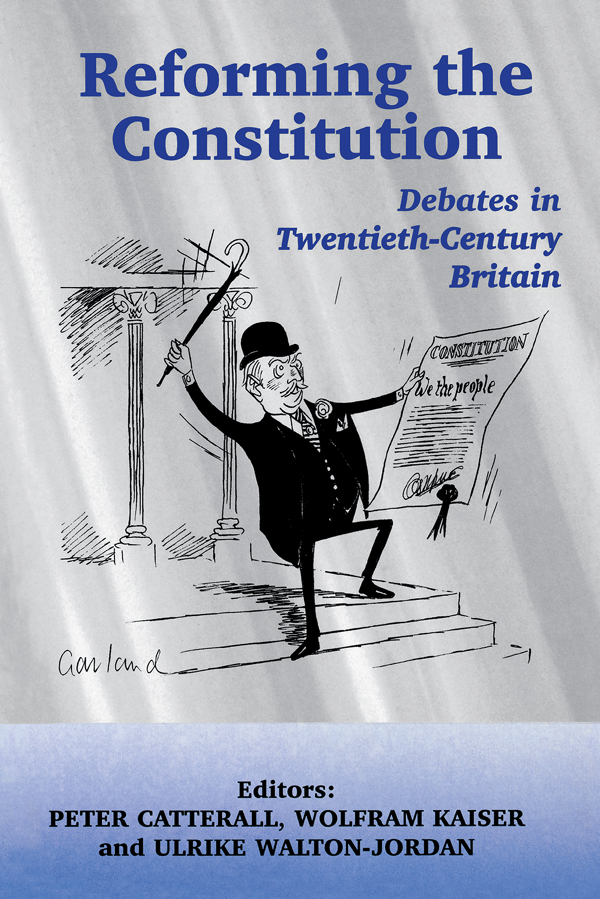
Reforming the Constitution This collection takes as its subject how and why the British constitution developed during the course of the 20th century. In chapters that analyse in detail the evolution of various aspects of the constitution, this work explores debates about how the constitution ought to operate and the political goods it ought to secure among politicians, jurists and academics. In addition, it looks at the influence of political parties, nationalism, social and economic change, European integration, and the contests in over particular reforms in Parliament, courts, media and on the hustings. POLITICAL SCIENCE,General
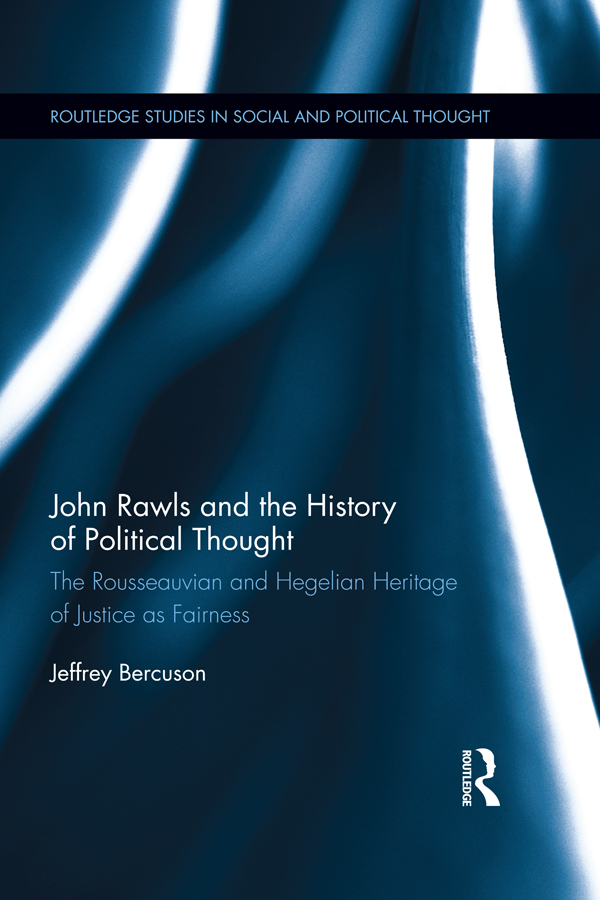
John Rawls and the History of Political Thought In this book, Jeffrey Bercuson presents the immense, and yet for the most part unrecognized, influences of Jean-Jacques Rousseau and Georg Wilhelm Friedrich Hegel on John Rawls, the most important political philosopher of the 20th century. While the well-documented influence of Immanuel Kant on Rawls is deep and profound, Kantian features and interpretation of justice as fairness do not tell the whole story about that doctrine. Drawing on Rawls’s Lectures on the History of Moral Philosophy and his Lectures on the History of Political Philosophy, Bercuson presents the reader with a more nuanced, accurate account of the moral and political philosophy of Rawls in light of these under-appreciated influences. This new, richer image of Rawls’s political philosophy shows that Rawls’s notion of reasonableness – his notion of the kind and extent of our obligations to those fellows with whom we are engaged in social cooperation – is conspicuously more demanding, and therefore more attractive, than most interpreters and critics assume. Rawls turns to Rousseau and to Hegel, both of whom provide attractive images of engaged citizenship worthy of emulation. Written accessibly, and contributing to key contemporary debates of global justice, this book will be read by scholars within the fields of social and political theory, ethics, and philosophy. POLITICAL SCIENCE,General
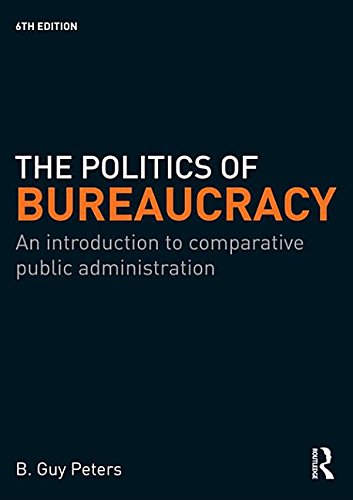
The Politics of Bureaucracy Written by a leading authority in the field, this comprehensive exploration of the political and policy-making roles of public bureaucracies is now available in a fully revised sixth edition, offering extensive, well documented comparative analysis of the effects of politics on bureaucracy. New to the 6th edition: More international case studies on North America, Western and Eastern European and Asian countries. Discussion of how governments have been developing strategies to enhance co-ordination and coherence across their programmes. Analysis of the use of performance management in public administration. More tables, case studies and internet links. Extensive revision and updating to take into account the wealth of new literature that has emerged in recent years, including a discussion of E-Governance and analysis of ‘new public management’. Drawing on evidence from a wide variety of political systems, The Politics of Bureaucracy continues to be essential reading for all students of government, policy analysis, and politics and international relations. POLITICAL SCIENCE,General
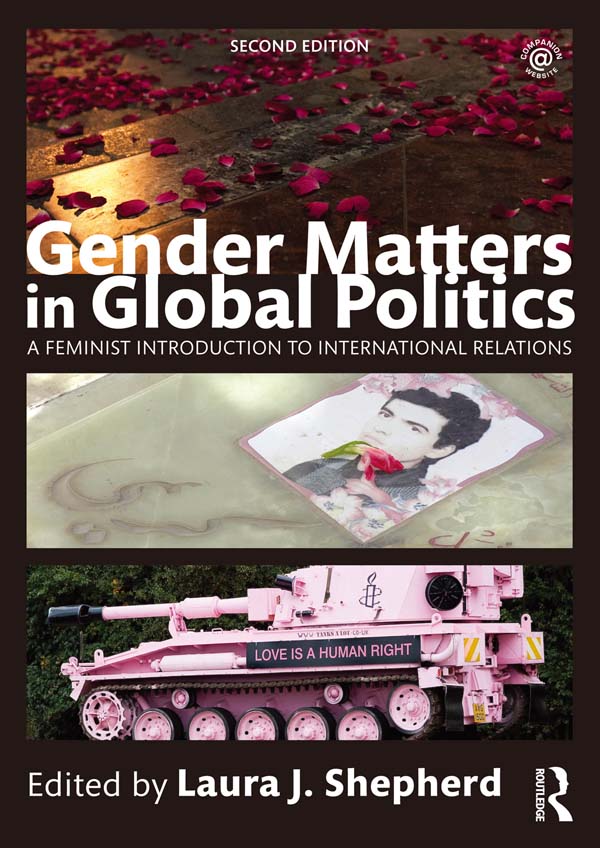
Gender Matters in Global Politics Fully revised and updated, this second edition of Gender Matters in Global Politics is a comprehensive textbook for advanced undergraduates studying feminism & international relations, gender and global politics and similar courses. It provides students with an accessible but in-depth account of the most significant theories, methodologies, debates and issues. This textbook is written by an international line-up of established and emerging scholars from a range of theoretical perspectives, and brings together cutting-edge feminist scholarship in a variety of issue areas. Key features and benefits of the book: Introduces students to the wide variety of feminist and gender theory and explains the relevance to contemporary global politics Explains the insights of feminist theory for a range of other disciplines including international relations, international political economy and security studies Addresses a large number of key contemporary issues such as human rights, trafficking, rape as a tool of war, peacekeeping and state-building, terrorism and environmental politics Features detailed pedagogical tools and resources – seminar exercises, text boxes, photographs, suggestions for further reading, web resources and a glossary of key terms New chapters on - Environmental politics and ecology; War; Terrorism and political violence; Land, food and water; International legal institutions; Peacebuilding institutions and post-conflict reconstruction; Citizenship; Art, aesthetics and emotionality; and New social media and global resistance. This text enables students to develop a sophisticated understanding of the work that gender does in policies and practices of global politics. POLITICAL SCIENCE,General
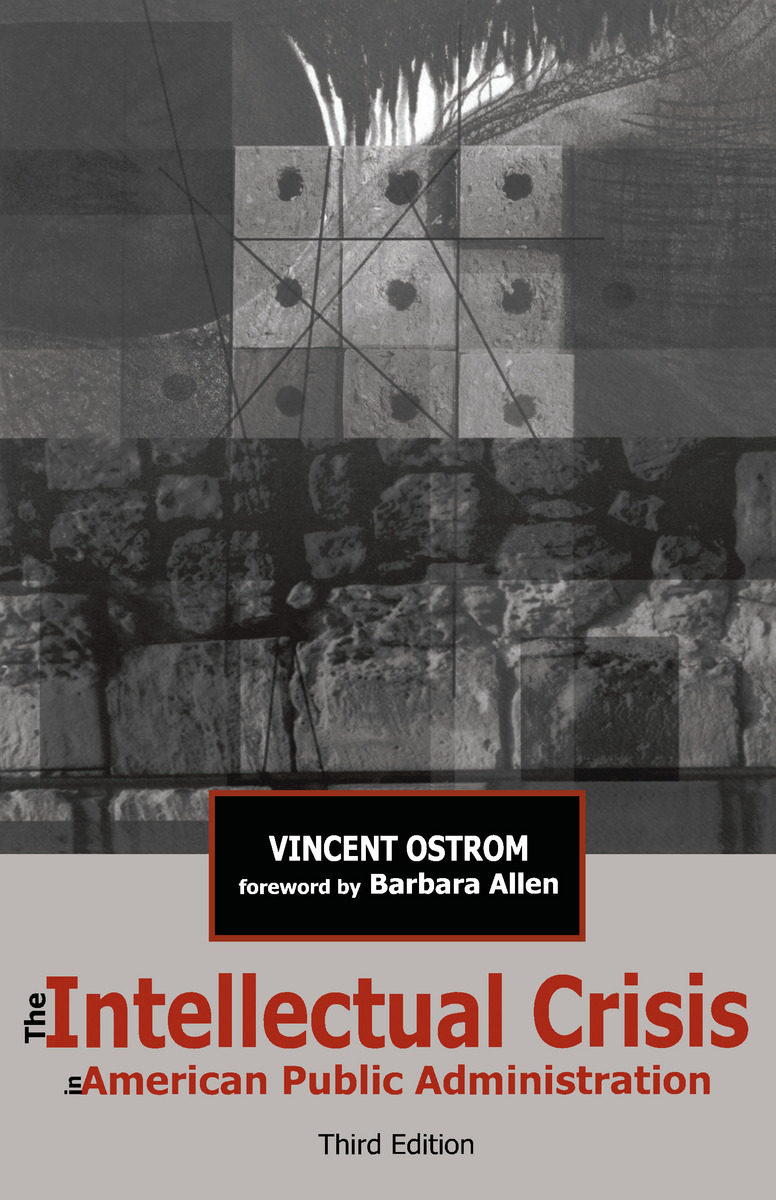
The Intellectual Crisis in American Public Administration This revised and expanded third edition extends Ostrom’s analysis to account for the most resent developments in American politics, including those of the Clinton and Bush administrations. POLITICAL SCIENCE,General

Second Treatise of Government This essential volume features John Locke's hand-corrected text with an outstanding introduction to Locke's life and role in intellectual history, his principal works, and their purpose. Written by the editor, Richard Cox, the introduction also outlines the course of both treatises of government and analyzes the problems of interpretation. Also included are a list of the principal dates in the life of John Locke as well as a selected bibliography. POLITICAL SCIENCE,General
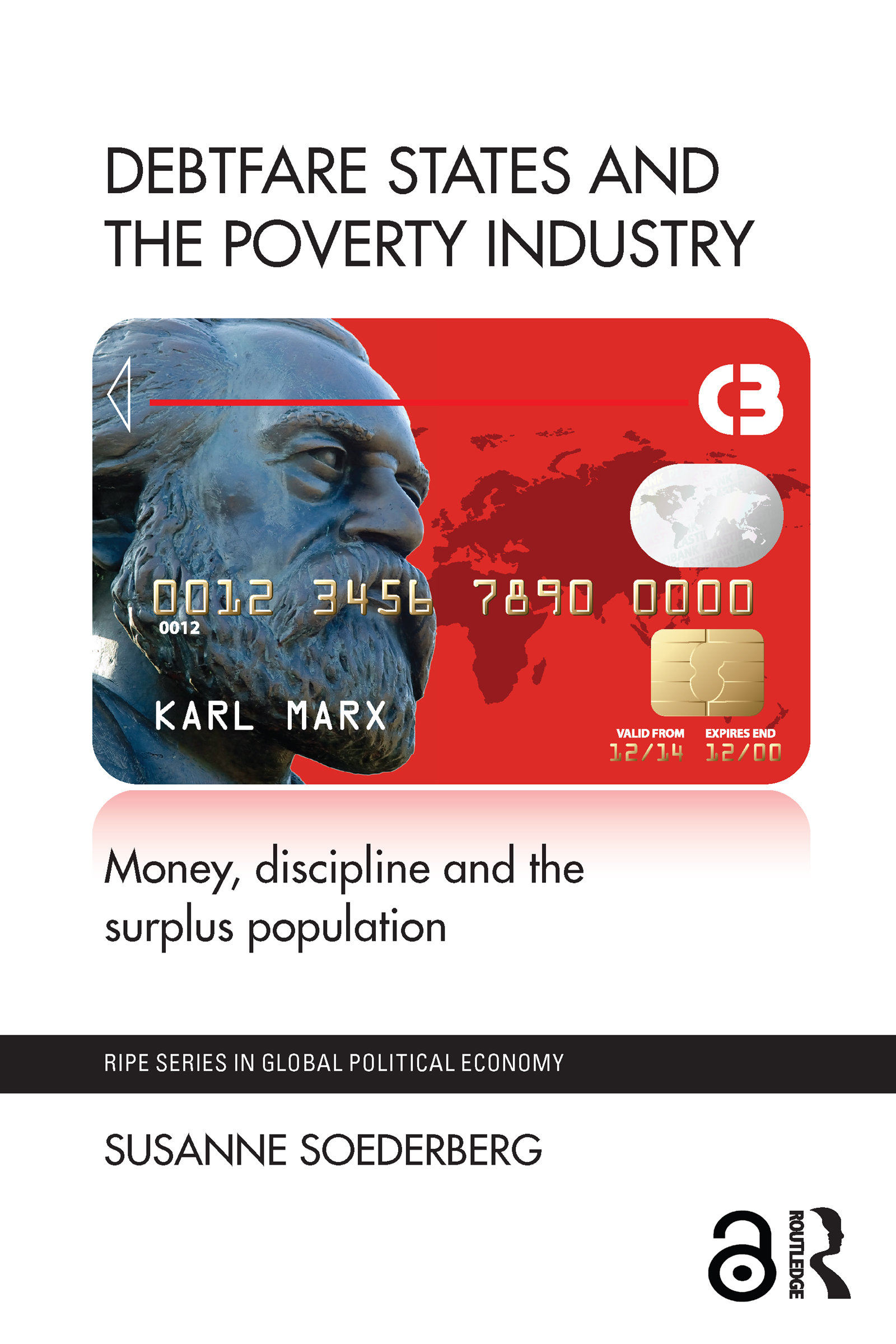
Debtfare States and the Poverty Industry WINNER of the BISA IPEG Book Prize 2015 http://www.bisa-ipeg.org/ipeg-book-prize-2015-winner-announced/ Under the rubric of ‘financial inclusion’, lending to the poor –in both the global North and global South –has become a highly lucrative and rapidly expanding industry since the 1990s. A key inquiry of this book is what is ‘the financial’ in which the poor are asked to join. Instead of embracing the mainstream position that financial inclusion is a natural, inevitable and mutually beneficial arrangement, Debtfare States and the Poverty Industry suggests that the structural violence inherent to neoliberalism and credit-led accumulation have created and normalized a reality in which the working poor can no longer afford to live without expensive credit. The book further transcends economic treatments of credit and debt by revealing how the poverty industry is extricably linked to the social power of money, the paradoxes in credit-led accumulation, and ‘debtfarism’. The latter refers to rhetorical and regulatory forms of governance that mediate and facilitate the expansion of the poverty industry and the reliance of the poor on credit to augment/replace their wages. Through a historically grounded analysis, the author examines various dimensions of the poverty industry ranging from the credit card, payday loan, and student loan industries in the United States to micro-lending and low-income housing finance industries in Mexico. Providing a much-needed theorization of the politics of debt, Debtfare States and the Poverty Industry has wider implications of the increasing dependence of the poor on consumer credit across the globe, this book will be of very strong interest to students and scholars of Global Political Economy, Finance, Development Studies, Geography, Law, History, and Sociology. https://www.youtube.com/watch?v=2lU6PHjyOzU POLITICAL SCIENCE,General
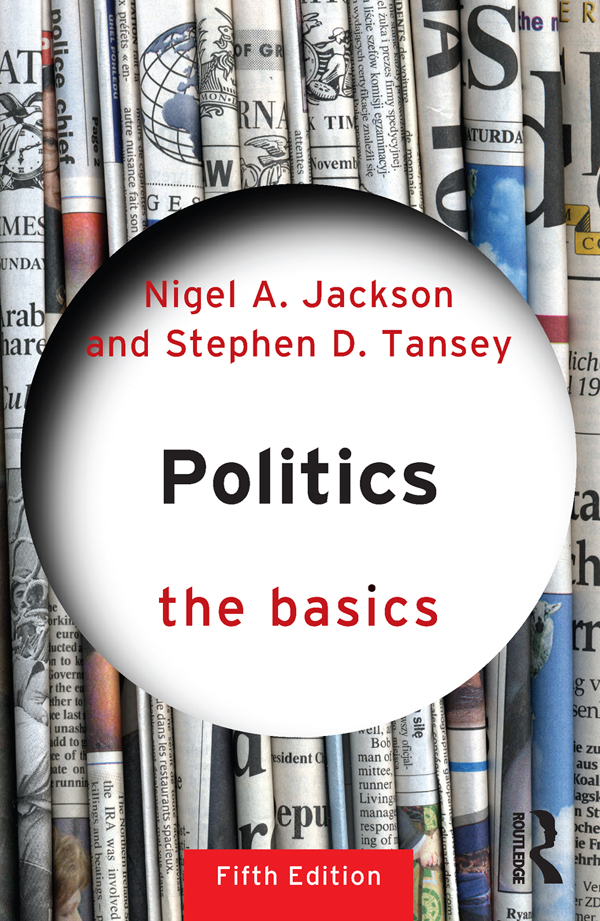
Politics Now in its fifth edition, Politics: The Basics explores the systems, movements and issues at the cutting edge of modern politics. A highly successful introduction to the world of politics, it offers clear and concise coverage of a range of issues and addresses fundamental questions such as: • Why does politics matter? • Why obey the state? • What are the key approaches to power? • How are political decisions made? • What are the current issues affecting governments worldwide? Accessible in style and topical in content, the fifth edition has been fully restructured to reflect core issues, systems and movements that are at the centre of modern politics and international relations. Assuming no prior knowledge in politics, it is ideal reading for anyone approaching the study of politics for the first time. POLITICAL SCIENCE,General

Central Debates in British Politics Central Debates in British Politics focuses on British politics in a changing social, economic and institutional context. The book explores issues and debates using a variety of approaches and techniques. It is written and edited by a team of leading experts who analyse key issues in a highly structured and thematic manner. POLITICAL SCIENCE,General

Public Administration and Society For instructors who want to expose their students to the social, political, and historical context of the practice of public administration, this book provides a unique approach to the introductory PA course. The author's own text is skilfully interwoven with a collection of seminal readings and documents that illuminate the key issues of past and present for public service professionals in a democratic society. More than an overview of public administration, Public Administration and Society offers students a broad perspective on the American Founding Era, the relationship of citizens to government, and how the structure of government reflects societal values. The premise of the book is that understanding the societal context is important to the success of the practitioner and to the practitioner's role as a responsible agent of change in a democratic society. Introductory essays and readings offer students perspectives on five important thematic areas in public administration: the Founding-Era debate over the size and scope of government, the relationship of the community to the individual, public organizations and policy making, values and public administration, and the role of the public service practitioner in a democratic society. This new edition of features five new readings, and, based on input from adopters, an entirely new section on public policy making (Part IV: Public Organizations and Policy). The author's part-opening sections have all been extensively revised and updated. POLITICAL SCIENCE,General

The Public Budgeting and Finance Primer This primer succinctly summarises key theoretical concepts in fiscal choice for both practitioners and scholars. The author contends that fiscal choice is ultimately a choice of both politics and economics. The book first introduces budget institutions and processes at various levels of government, which restrict budget decision makers' discretion. It also explains budget decision makers' efforts to make rational resource allocations. It then shows how and why such efforts are stymied by the decision makers' capacity and institutional settings. The book's unique benefit is its emphasis on all the essential topics, with short, module-type chapters which can be read in any order. POLITICAL SCIENCE,General
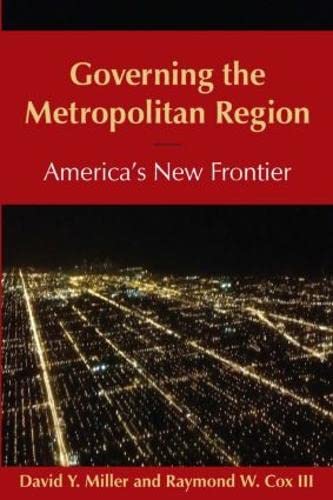
Governing the Metropolitan Region This text is aimed at the basic local government management course (upper division or graduate) that addresses the structural, political and management issues associated with regional and metropolitan government. It also can complement more specialized courses such as urban planning, urban government, state and local politics, and intergovernmental relations. POLITICAL SCIENCE,General
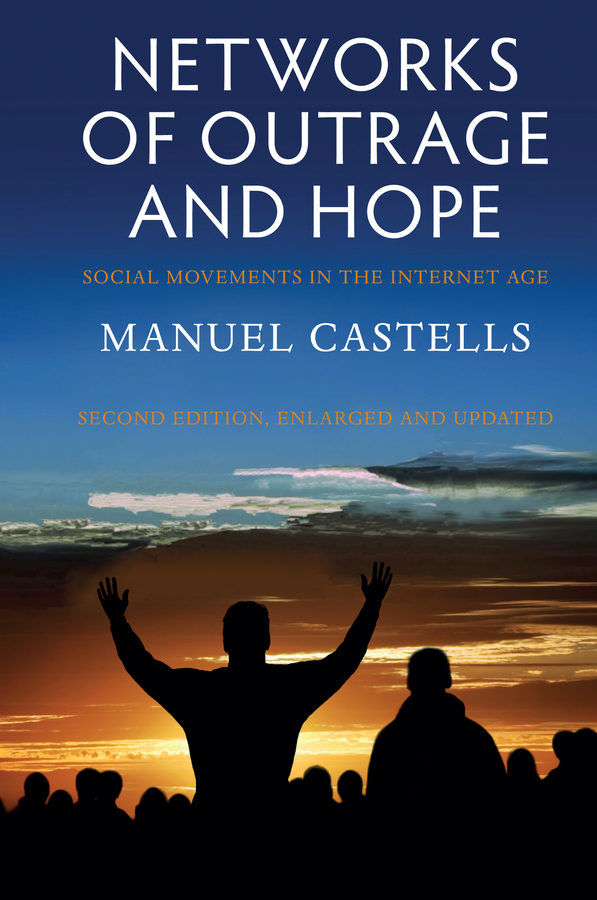
Networks of Outrage and Hope Networks of Outrage and Hope is an exploration of the new forms of social movements and protests that are erupting in the world today, from the Arab uprisings to the indignadas movement in Spain, from the Occupy Wall Street movement to the social protests in Turkey, Brazil and elsewhere. While these and similar social movements differ in many important ways, there is one thing they share in common: they are all interwoven inextricably with the creation of autonomous communication networks supported by the Internet and wireless communication. In this new edition of his timely and important book, Manuel Castells examines the social, cultural and political roots of these new social movements, studies their innovative forms of self-organization, assesses the precise role of technology in the dynamics of the movements, suggests the reasons for the support they have found in large segments of society, and probes their capacity to induce political change by influencing people’s minds. Two new chapters bring the analysis up-to-date and draw out the implications of these social movements and protests for understanding the new forms of social change and political democracy in the global network society. POLITICAL SCIENCE,General
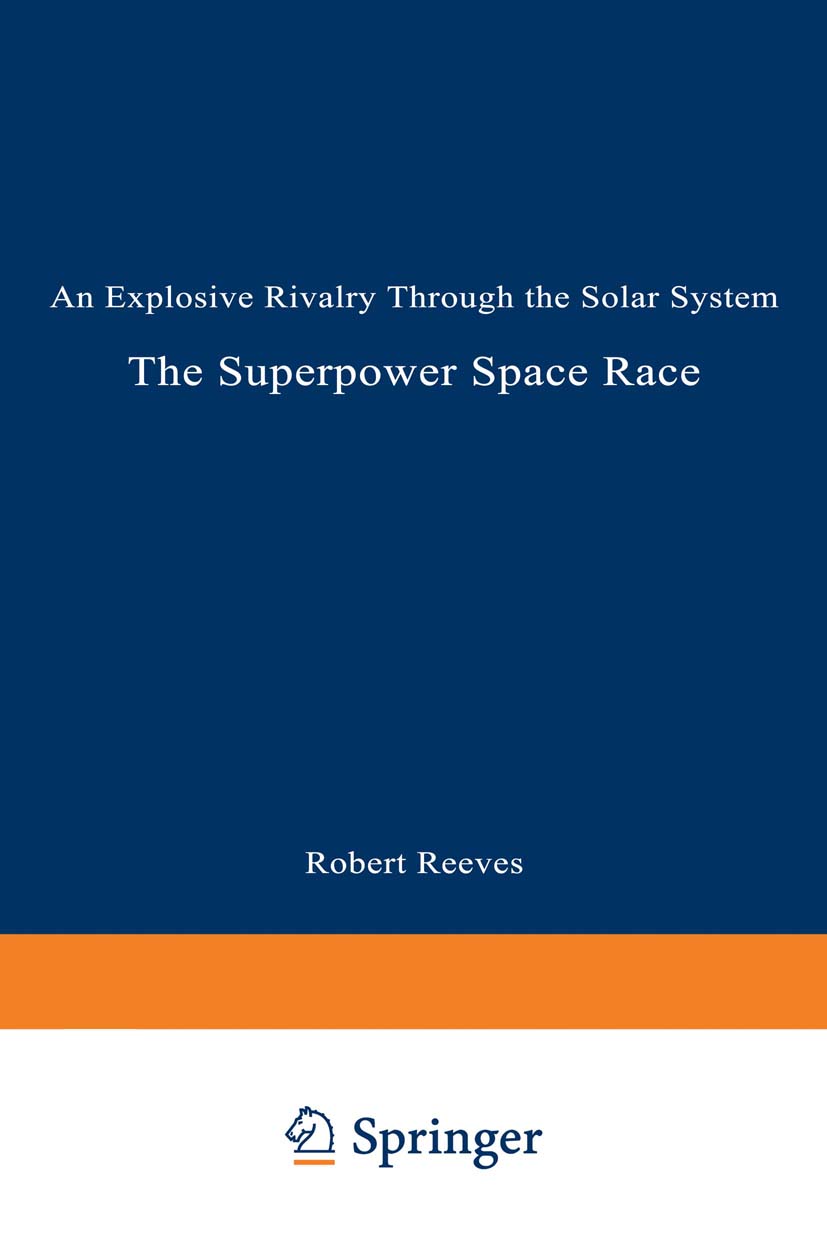
The Superpower Space Race POLITICAL SCIENCE,General
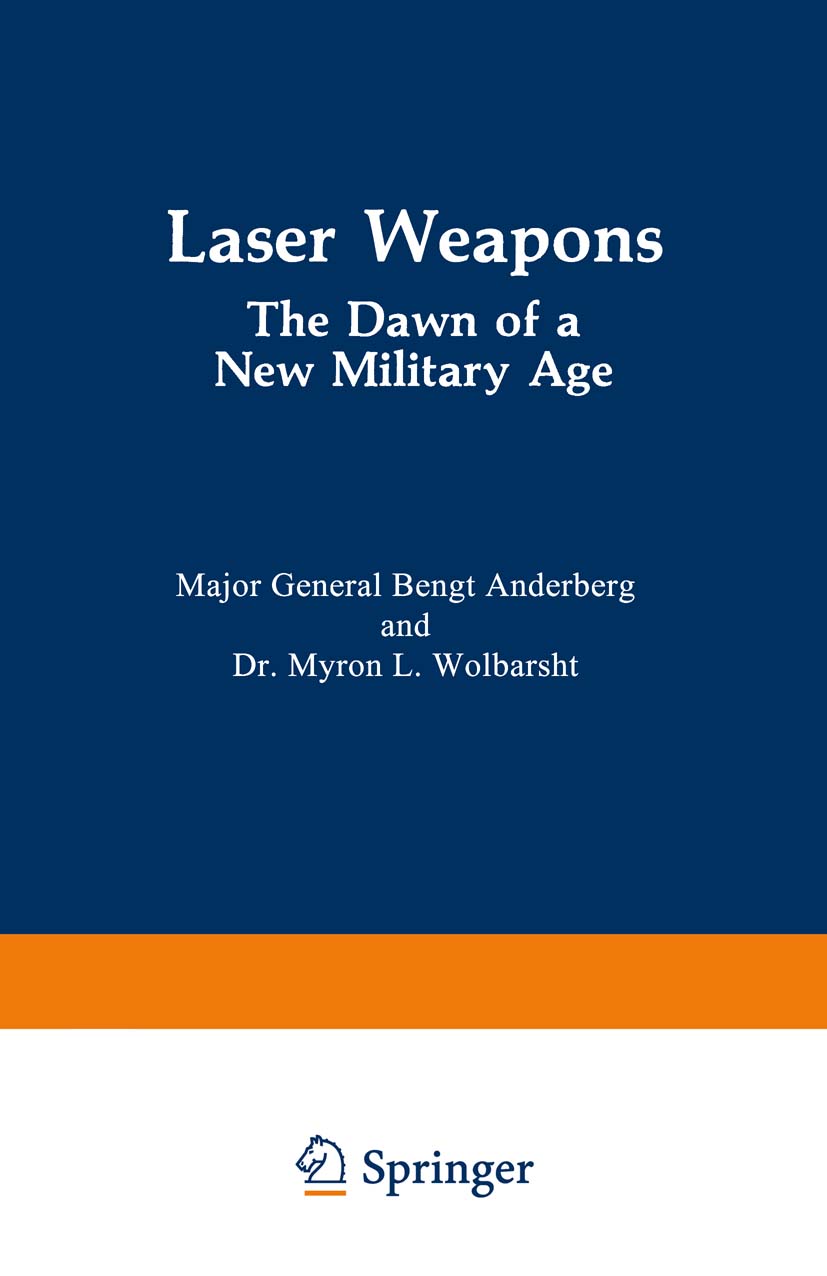
Laser Weapons POLITICAL SCIENCE,General
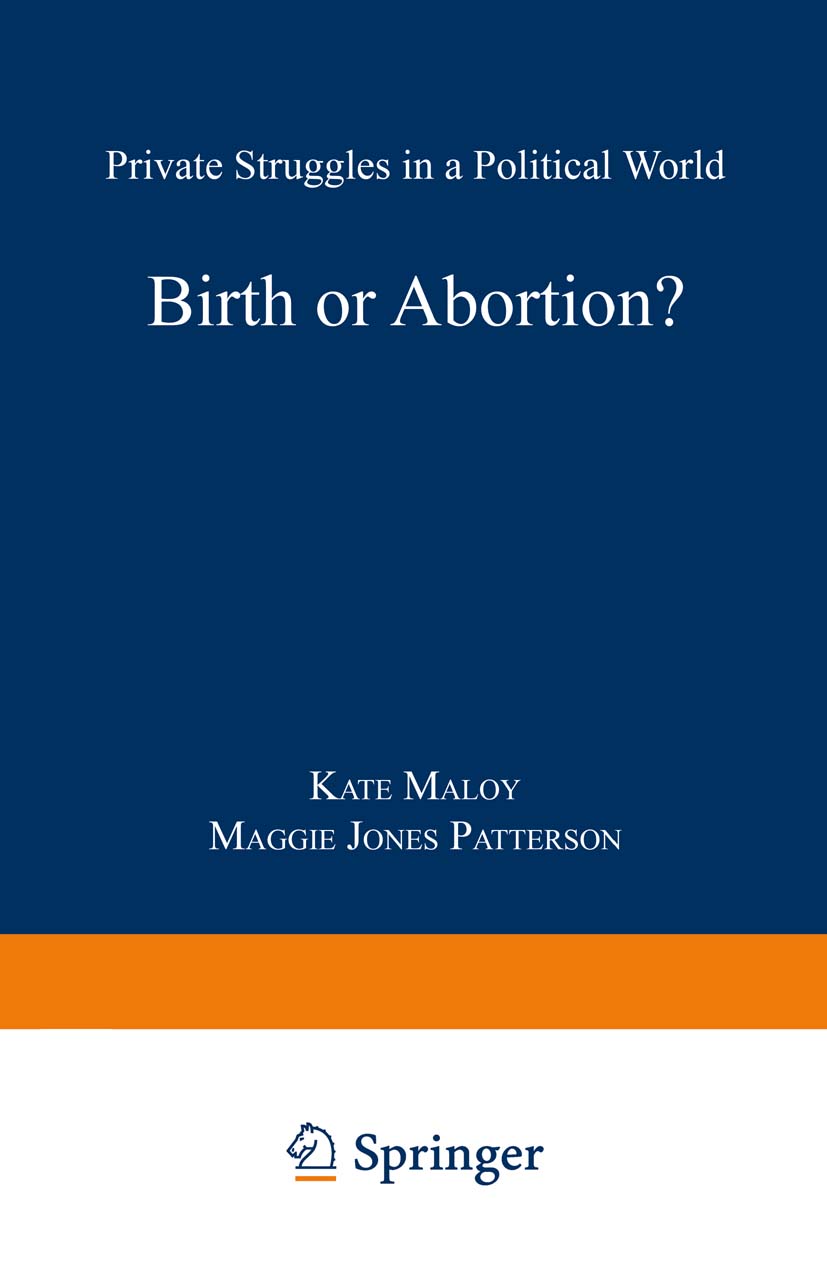
Birth or Abortion? POLITICAL SCIENCE,General
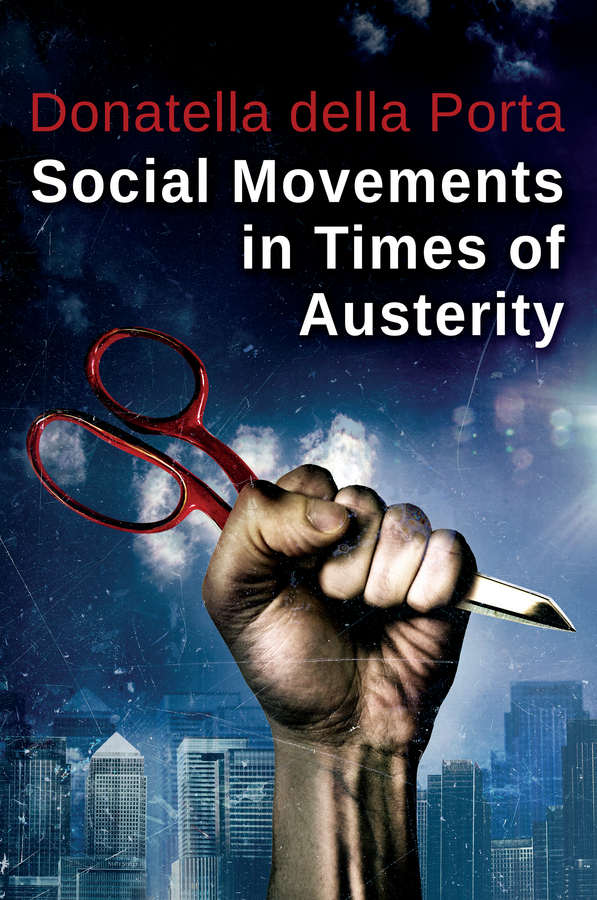
Social Movements in Times of Austerity Recent years have seen an enormous increase in protests across the world in which citizens have challenged what they see as a deterioration of democratic institutions and the very civil, political and social rights that form the basis of democratic life. Beginning with Iceland in 2008, and then forcefully in Egypt, Tunisia, Spain, Greece and Portugal, or more recently in Peru, Brazil, Russia, Bulgaria, Turkey and Ukraine, people have taken to the streets against what they perceive as a rampant and dangerous corruption of democracy, with a distinct focus on inequality and suffering. This timely new book addresses the anti-austerity social movements of which these protests form part, mobilizing in the context of a crisis of neoliberalism. Donatella della Porta shows that, in order to understand their main facets in terms of social basis, strategy, and identity and organizational structures, we should look at the specific characteristics of the socioeconomic, cultural and political context in which they developed. The result is an important and insightful contribution to understanding a key issue of our times, which will be of interest to students and scholars of political and economic sociology, political science and social movement studies, as well as political activists. POLITICAL SCIENCE,General

Swissness in a Nutshell BEVOR SIE DIESES ERWEITERTE E-BOOK KAUFEN, PRÜFEN SIE BITTE, OB IHR LESEGERÄT FIXED LAYOUT FORMATE WIEDERGEBEN KANN.What is Switzerland? With more than two hundred full-colour cartoons, photos, and works of art this accessible guide illuminates the unique alpine nation. From William Tell to Heidi, Swiss Army Knives to cheese, litter-free streets to punctual trains. Winner of the 2013 Albert Oeri Democracy Prize. POLITICAL SCIENCE,General

Swiss Democracy in a Nutshell BEVOR SIE DIESES ERWEITERTE E-BOOK KAUFEN, PRÜFEN SIE BITTE, OB IHR LESEGERÄT FIXED LAYOUT FORMATE WIEDERGEBEN KANN.Short description: An accessible, illustrated introduction to Switzerland?s unique form of democracy. Written by well-known comedian and political scientist Vincent Kucholl, and illustrated by Mix&Remix, the book is both for those new to Switzerland as well as anyone who would like to finally understand direct democracy, political parties, or what goes on in Bern. Translated from the French. Winner of the 2013 Albert Oeri Democracy Prize. POLITICAL SCIENCE,General
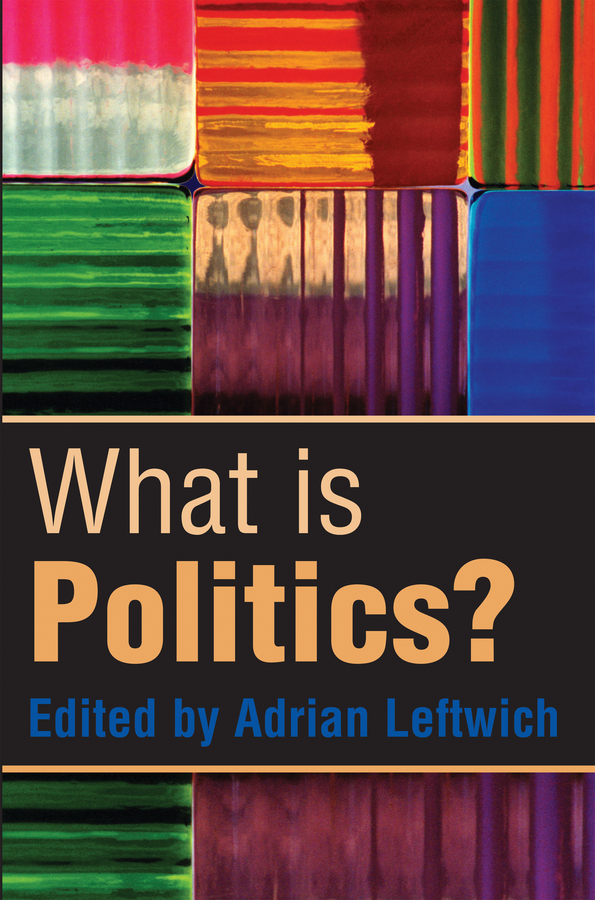
What is Politics? What is politics? Is it a universal feature of all human societies, past and present? Is it tied to specific institutional arenas? Or is it found in all groups and organizations, large or small, formal or informal? This new textbook seeks to provide answers to these important questions. Starting with what it means to ‘think politically’, the book goes on to explore a wide range of meanings attributed to the concept of politics from a variety of perspectives and theoretical traditions. It offers succinct and coherent overviews by some of the foremost scholars in the field, and each invites the reader to see the activity of politics in a distinctive way. Topics covered include politics as a form of rule, feminist approaches to politics, Marxism and politics, the politics of human behaviour, environmental politics, politics as collective choice, and Islam and politics. Written with the new student in mind, this concise introduction to the study and activity of politics is essential reading for all those coming to the discipline for the first time. POLITICAL SCIENCE,General
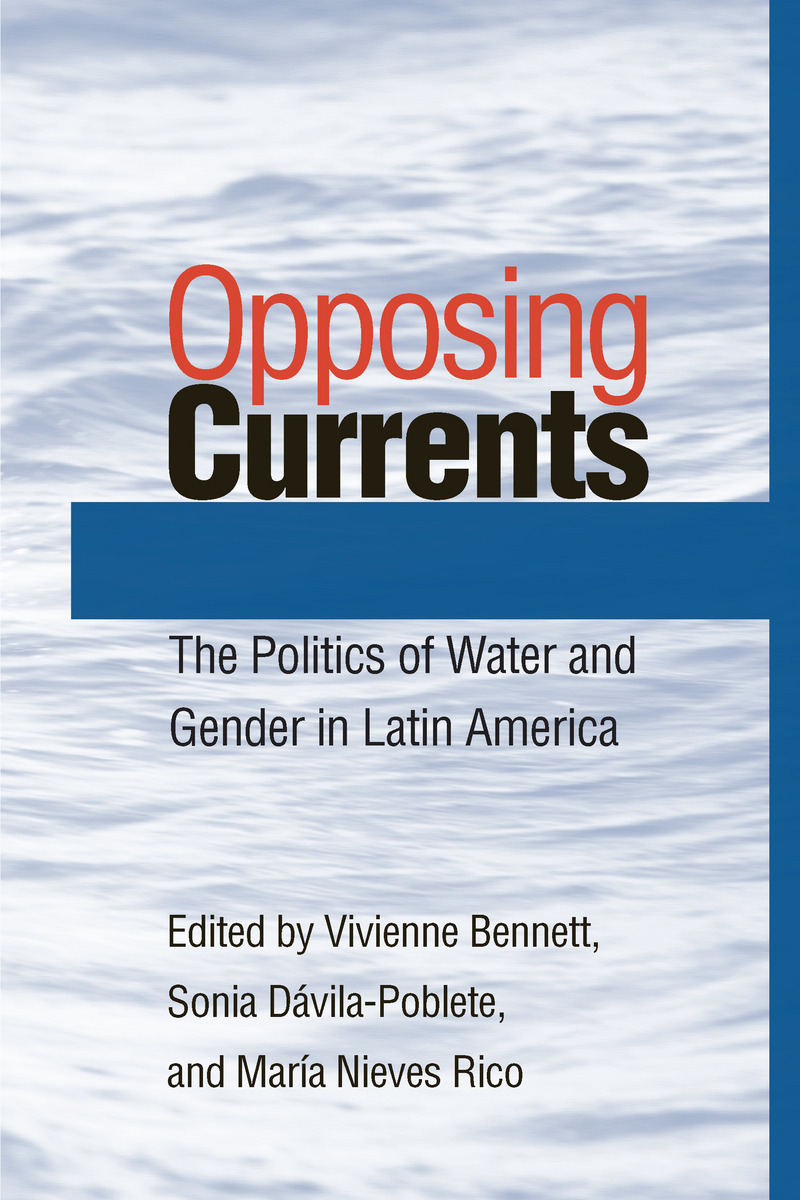
Opposing Currents This volume focuses on women in Latin America as stakeholders in water resources management. It makes their contributions to grassroots efforts more visible, explains why doing so is essential for effective public policy and planning in the water sector, and provides guidelines for future planning and project implementation. After an in-depth review of gender and water management policies and issues in relation to domestic usage, irrigation, and sustainable development, the book provides a series of case studies prepared by an interdisciplinary group of scholars and activists. Covering countries throughout the hemisphere, and moving freely from impoverished neighborhoods to the conference rooms of international agencies, the book explores the various ways in which women are-and are not-involved in local water initiatives across Latin America. Insightful analyses reveal what these case studies imply for the success or failure of various regional efforts to improve water accessibility and usability, and suggest new ways of thinking about gender and the environment in the context of specific policies and practices. POLITICAL SCIENCE,General

Organized Crime and Democratic Governability The United States–Mexico border zone is one of the busiest and most dangerous in the world. NAFTA and rapid industrialization on the Mexican side have brought trade, travel, migration, and consequently, organized crime and corruption to the region on an unprecedented scale. Until recently, crime at the border was viewed as a local law enforcement problem with drug trafficking—a matter of “beefing†up police and “hardening†the border. At the turn of the century, that limited perception has changed. The range of criminal activity at the border now extends beyond drugs to include smuggling of arms, people, vehicles, financial instruments, environmentally dangerous substances, endangered species, and archeological objects. Such widespread trafficking involves complex, high-level criminal-political alliances that local lawenforcement alone can’t address. Researchers of the region, as well as officials from both capitals, now see the border as a set of systemic problems that threaten the economic, political, and social health of their countries as a whole. Organized Crime and Democratic Governability brings together scholars and specialists, including current and former government officials, from both sides of the border to trace the history and define the reality of this situation. Their diverse perspectives place the issue of organized crime in historical, political, economic, and cultural contexts unattainable by single-author studies. Contributors examine broad issues related to the political systems of both countries, as well as the specific actors—crime gangs, government officials, prosecutors, police, and the military—involved in the ongoing drama of the border. Editors Bailey and Godson provide an interpretive frame, a “continuum of governability,†that will guide researchers and policymakers toward defining goals and solutions to the complex problem that, along with a border, the United States and Mexico now share. POLITICAL SCIENCE,General

Authenticity, Autonomy and Multiculturalism The concept of "authenticity" enters multicultural politics in three distinct but interrelated senses: as an ideal of individual and group identity that commands recognition by others; as a condition of individuals’ autonomy that bestows legitimacy on their values, beliefs and preferences as being their own; and as a form of cultural pedigree that bestows legitimacy on particular beliefs and practices (commonly called "cultural authenticity"). In each case, the authenticity idea is called on to anchor or legitimate claims to some kind of public recognition. The considerable work asked of this concept raises a number of vital questions: Should "authenticity" be accorded the importance it holds in multicultural politics? Do its pitfalls outweigh its utility? Is the notion of "authenticity" avoidable in making sense of and evaluating cultural claims? Or does it, perhaps, need to be rethought or recalibrated? Geoffrey Brahm Levey and his distinguished group of philosophers, political theorists, and anthropologists challenge conventional assumptions about "authenticity" that inform liberal responses to minority cultural claims in Western democracies today. Discussing a wide range of cases drawn from Britain and continental Europe, North America, Australia and the Middle East, they press beyond theories to consider also the practical and policy implications at stake. A helpful resource to scholars worldwide in Political and Social Theory, Political Philosophy, Legal Anthropology, Multiculturalism, and, more generally, of cultural identity and diversity in liberal democracies today. POLITICAL SCIENCE,General
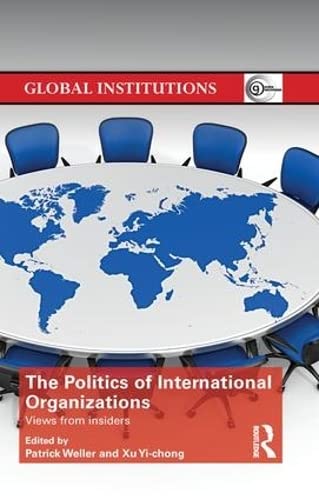
The Politics of International Organizations International organisations (IOs) often receive a bad press, seen as intrusive, domineering and unresponsive to the needs of the people and countries they are meant to serve. The best way to understand the operation of these international organisations is to bring together those who represent their countries at IOs and those who have been working at IOs at various capacities and then to listen to their experiences. This book develops an alternative approach to the analysis of IOs that takes account of all those involved, whether state representatives, IO leaders and members of the secretariat. Experts with long experience in the WTO, the World Bank, the IMF, WIPO, the FAO and the WHO at senior level consider the workings of the IOs, and a conclusion that explicitly draws out the comparative lessons and contrasts the insights of practitioners from those of external observers. This book takes an alternative approach to the analysis of IOs that takes account of all those involved, whether state representatives, IO leaders and members of the secretariat. Providing a well-informed, innovative and consistently structured analysis of IOs this work will be of interest to students and scholars of international relations, international organizations and global governance. POLITICAL SCIENCE,General

The End of Representative Politics Representative politics is in crisis. Trust in politicians is at an all-time low. Fewer people are voting or joining political parties, and our interest in parliamentary politics is declining fast. Even oppositional and radical parties that should be benefitting from public disenchantment with politics are suffering. But different forms of political activity are emerging to replace representative politics: instant politics, direct action, insurgent politics. We are leaving behind traditional representation, and moving towards a politics without representatives. In this provocative new book, Simon Tormey explores the changes that are underway, drawing on a rich range of examples from the Arab Spring to the Indignados uprising in Spain, street protests in Brazil and Turkey to the emergence of new initiatives such as Anonymous and Occupy. Tormey argues that the easy assumptions that informed our thinking about the nature and role of parties, and ‘party based democracy’ have to be rethought. We are entering a period of fast politics, evanescent politics, a politics of the street, of the squares, of micro-parties, pop-up parties, and demonstrations. This may well be the end of representative politics as we know it, but an exciting new era of political engagement is just beginning. POLITICAL SCIENCE,General

Philosophical Perspectives on the Israeli-Palestinian Conflict This volume addresses a number of philosophical problems that arise in consideration of the century-old conflict between Israeli Jews and Palestinian Arabs. Consisting of essays by fifteen contributors (including both Israeli and Palestinian philosophers) and a lengthy introduction by the editor, it deals with rights to land, sovereignity, self-determination, the existence and legitimacy of states, cultural prejudice, national identity, intercommunal violence, and religious intransigence. POLITICAL SCIENCE,General
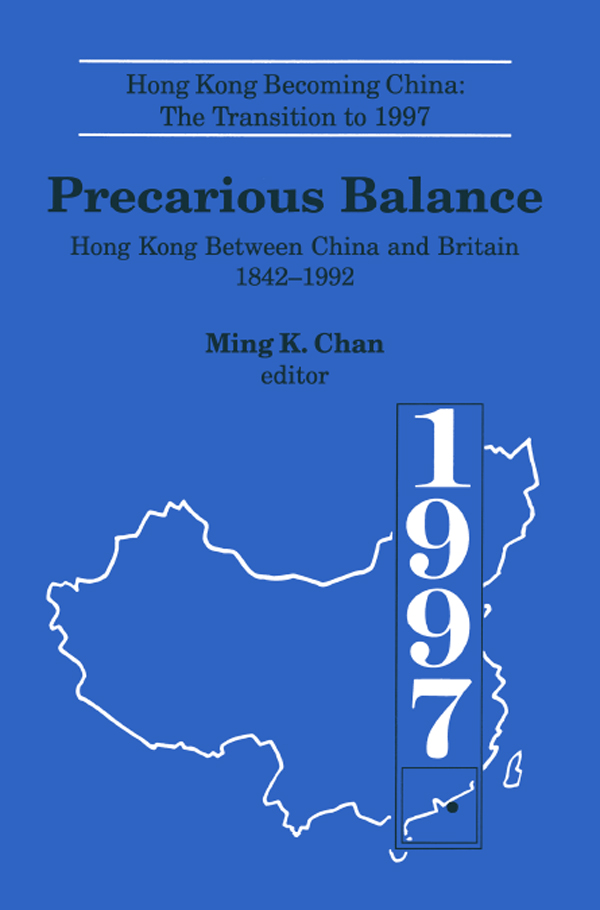
Precarious Balance This work closely considers the history and political importance of Hong Kong in the period 1842 to 1992. POLITICAL SCIENCE,General

Confronting Black Jacobins The Haitian Revolution, the product of the first successful slave revolt, was truly world-historic in its impact. When Haiti declared independence in 1804, the leading powers—France, Great Britain, and Spain—suffered an ignominious defeat and the New World was remade. The island revolution also had a profound impact on Haiti’s mainland neighbor, the United States. Inspiring the enslaved and partisans of emancipation while striking terror throughout the Southern slaveocracy, it propelled the fledgling nation one step closer to civil war. Gerald Horne’s path breaking new work explores the complex and often fraught relationship between the United States and the island of Hispaniola. Giving particular attention to the responses of African Americans, Horne surveys the reaction in the United States to the revolutionary process in the nation that became Haiti, the splitting of the island in 1844, which led to the formation of the Dominican Republic, and the failed attempt by the United States to annex both in the 1870s.Drawing upon a rich collection of archival and other primary source materials, Horne deftly weaves together a disparate array of voices—world leaders and diplomats, slaveholders, white abolitionists, and the freedom fighters he terms Black Jacobins. Horne at once illuminates the tangled conflicts of the colonial powers, the commercial interests and imperial ambitions of U.S. elites, and the brutality and tenacity of the American slaveholding class, while never losing sight of the freedom struggles of Africans both on the island and on the mainland, which sought the fulfillment of the emancipatory promise of 18th century republicanism. POLITICAL SCIENCE,General
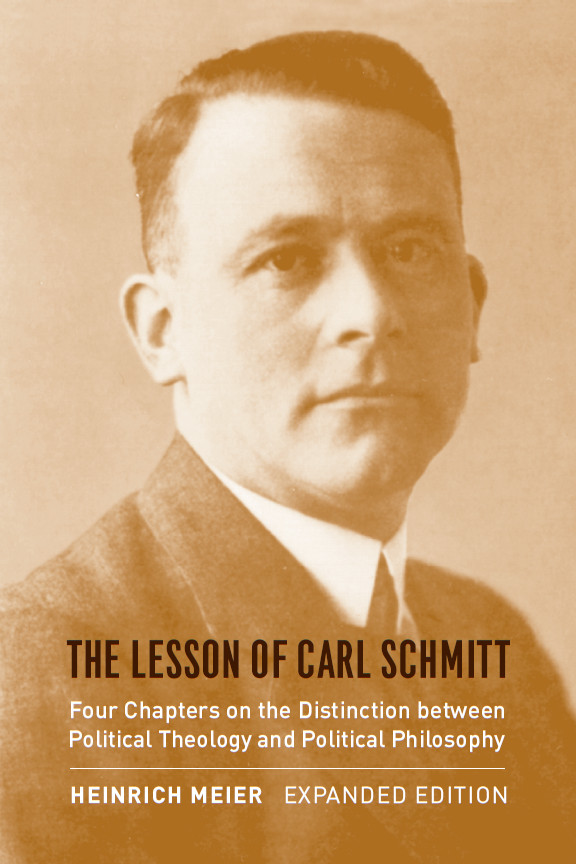
The Lesson of Carl Schmitt Heinrich Meier’s work on Carl Schmitt has dramatically reoriented the international debate about Schmitt and his significance for twentieth-century political thought. In The Lesson of Carl Schmitt, Meier identifies the core of Schmitt’s thought as political theology—that is, political theorizing that claims to have its ultimate ground in the revelation of a mysterious or suprarational God. This radical, but half-hidden, theological foundation underlies the whole of Schmitt’s often difficult and complex oeuvre, rich in historical turns and political convolutions, intentional deceptions and unintentional obfuscations. In four chapters on morality, politics, revelation, and history, Meier clarifies the difference between political philosophy and Schmitt’s political theology and relates the religious dimension of his thought to his support for National Socialism and his continuing anti-Semitism. New to this edition are two essays that address the recently published correspondences of Schmitt—particularly with Hans Blumberg—and the light it sheds on his conception of political theology. POLITICAL SCIENCE,General

Environment and Politics Environment and Politics 4th Edition is a concise introduction to this ever-expanding interdisciplinary field, explaining and illustrating how concepts, conflicts, movements, political systems and the practices of policy-making can be analysed in a systematic way. This book provides a comprehensive overview of the key themes that shape the field, and examines a diverse range of environmental problems and policy solutions found in different countries and cultures. The new edition has been extensively revised to include up-to-date explanation of green political theories and traditions and the debates that shape action on the ground. It contains an expanded discussion of environmental movements that work in the Global North, the Global South and transnationally. Greater attention has been given to the roles of corporations, non-governmental organizations, the media, consumers and citizens in order to reflect the changing nature of environmental governance. The text also focuses throughout on debates surrounding the concepts of environmental security, environmental justice and environmental citizenship. The authors examine the institutional responses of parliaments, administrative, legal and electoral systems; the more informal politics of social movements; and the politics of markets and the corporate sector as they respond to (or resist) the greening of societies. This engaging text has been fully updated to offer readers a greater understanding of international, national and local environmental politics as well as expected future developments at all levels. Environment and Politics continues to use illustrative examples of conflicts, people and events spanning North and South America, Europe, Asia, Africa and Australia, giving it global perspective and relevance. Each chapter includes questions for debate as well as a list of key words and resources for independent research. This successful textbook remains a key resource for undergraduate and postgraduate studies across politics, environmental studies, development studies and human geography courses. POLITICAL SCIENCE,General
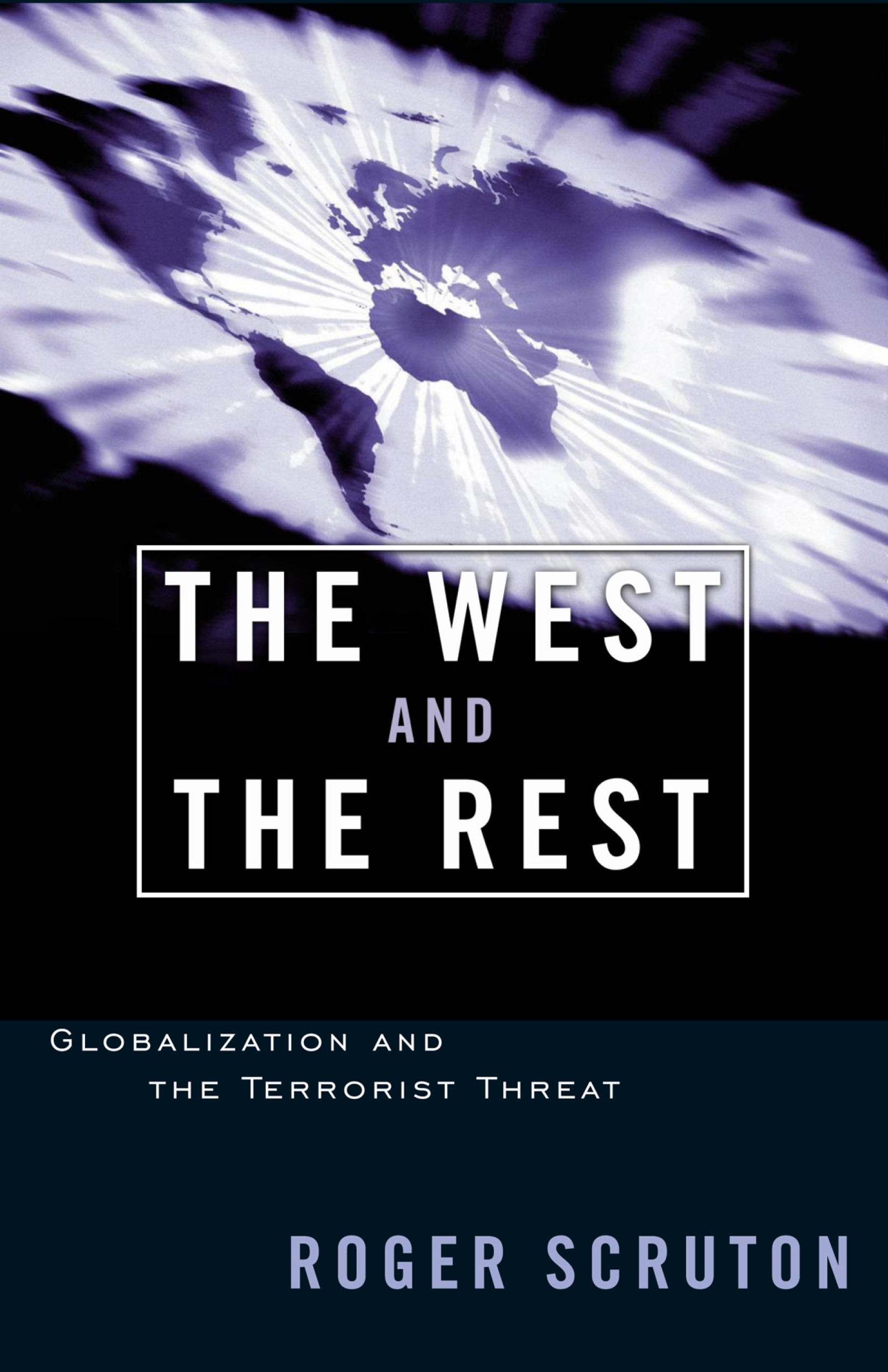
The West and the Rest Scruton shows how the different religious and philosophical roots of Western and Islamic societies have resulted in those societies’ profoundly divergent beliefs about the nature of political order. For one thing, the idea of the social contract, crucial to the self-conception of Western nations, is entirely absent in Islamic societies. Similarly, Scruton explains why the notions of territorial jurisdiction, citizenship, and the independent legitimacy of secular authority and law are both specifically Western and fundamentally antipathetic to Islamic thought. And yet, says Scruton, for its adherents Islam provides amply for one of the most fundamental of human needs: the need for membership. In contrast, the decay of the West’s own political vision, and its concomitant preoccupation with individual choice, has finally led to a “culture of repudiation†in which that need goes increasingly unfulfilled, principally because the sources of its fulfillment—patriotism, religious belief, traditional ways of life—are routinely mocked. Globalization has made these facts an explosive mixture. Migration, modern communications, and the media have inexorably brought the formerly remote inhabitants of Islamic nations into constant contact with the images, products, and peoples of secular, liberal democracies. Scruton warns that in light of this new reality, certain Western assumptions—about consumption and prosperity, about borders and travel, about free trade and multinational corporations, and about multiculturalism—need to be thoroughly re-evaluated. The West and the Rest is a major contribution to the West’s public discourse about terrorism, civil society, and liberal democracy. POLITICAL SCIENCE,General

The Prince (Collins Classics) HarperCollins is proud to present its new range of best-loved, essential classics. POLITICAL SCIENCE,General

Politics Ideas in Profile: Small Introductions to Big Topics In the first title of an exciting new series one of the world's leading political scientists asks the big questions about politics: what is it, why we do we need it and where, in these turbulent times, is it heading? From the gap between rich and poor to the impact of social media, via Machiavelli, Hobbes and Weber, Runciman's comprehensive short introduction is invaluable to those studying politics or those who want to know how life in Denmark became more comfortable than in Syria. The Ideas in Profile series is what introductions can and should be. Concise, clear, relevant, entertaining, original and global in scope, Politics makes essential reading for anyone, from students to the general reader. POLITICAL SCIENCE,General

Escalation and Nuclear Option This work stresses the importance, in making any choice of strategies-including the decision to use or refrain from using nuclear weapons-of gauging the intent behind the opponent's military moves. Dr. Brodie also suggests that the use or threat of use of tactical nuclear weapons may lead to de-escalation, that is, may check rather than promote the expansion of hostilities. The author applies his ideas about escalation to several imagined situations, examining them in relation to experiences in Europe, in the second Cuba crisis, and in Asia. Originally published in 1966. The Princeton Legacy Library uses the latest print-on-demand technology to again make available previously out-of-print books from the distinguished backlist of Princeton University Press. These editions preserve the original texts of these important books while presenting them in durable paperback and hardcover editions. The goal of the Princeton Legacy Library is to vastly increase access to the rich scholarly heritage found in the thousands of books published by Princeton University Press since its founding in 1905. POLITICAL SCIENCE,General

Who's Running America? A classic of American government, Who's Running America? continues to demonstrate how power is concentrated in large institutions no matter who inhabits the White House. The eighth edition of this best-selling text focuses on the Obama administration and the ways in which it is different from but also similar to administrations that have come before. Based on years of exhaustive data compilation and analysis, Who's Running America? explores the influence and impact of governmental leaders, corporate officials, and other elites both inside and outside the United States. Employing an oligarchic model of national policymaking, Tom Dye doesn't just lay out theory and data. He very consciously "names names" in describing the people who inhabit the White House, the Cabinet, the leaders of Congress, members of the Supreme Court, as well as the board rooms of the nation's largest corporations and banks including leading media lights as well as "fat cat" political contributors. Dye argues that big institutions run America, but also that these institutions are made up of real people. Who's Running America? puts the flesh and bones on the statistics and delivers the inside scoop on the Obama reign. POLITICAL SCIENCE,General

Face of Imperialism The relationship between US economic and military power is not often considered within mainstream commentary. Similarly the connection between US military interventions overseas and US domestic problems is rarely considered in any detail. In this brilliant new book, Michael Parenti reveals the true face of US imperialism. He documents how it promotes unjust policies across the globe including expropriation of natural resources, privatisation, debt burdens and suppression of democratic movements. He then demonstrates how this feeds into deteriorating living standards in the US itself, leading to increased poverty, decaying infrastructure and impending ecological disaster. The Face of Imperialism redefines empire and imperialism and connects the crisis in the US with its military escapades across the world. POLITICAL SCIENCE,General

The Prince The ultimate treatise on statecraft. Machiavelli's work has held such power to shock that he was at one time identified with Satan himself. Published in 1532, it remains relevant -- and fascinating -- for modern readers. Sayre Street Books offers the world's greatest literature in easy to navigate, beautifully designed digital editions. POLITICAL SCIENCE,General
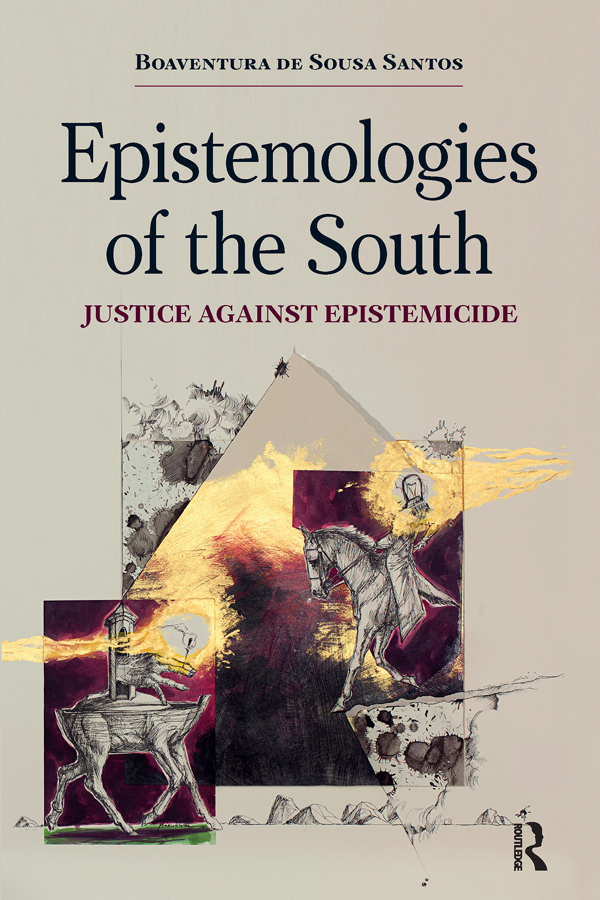
Epistemologies of the South This book explores the concept of 'cognitive injustice': the failure to recognise the different ways of knowing by which people across the globe run their lives and provide meaning to their existence. Boaventura de Sousa Santos shows why global social justice is not possible without global cognitive justice. Santos argues that Western domination has profoundly marginalised knowledge and wisdom that had been in existence in the global South. She contends that today it is imperative to recover and valorize the epistemological diversity of the world. Epistemologies of the South outlines a new kind of bottom-up cosmopolitanism, in which conviviality, solidarity and life triumph against the logic of market-ridden greed and individualism. POLITICAL SCIENCE,General
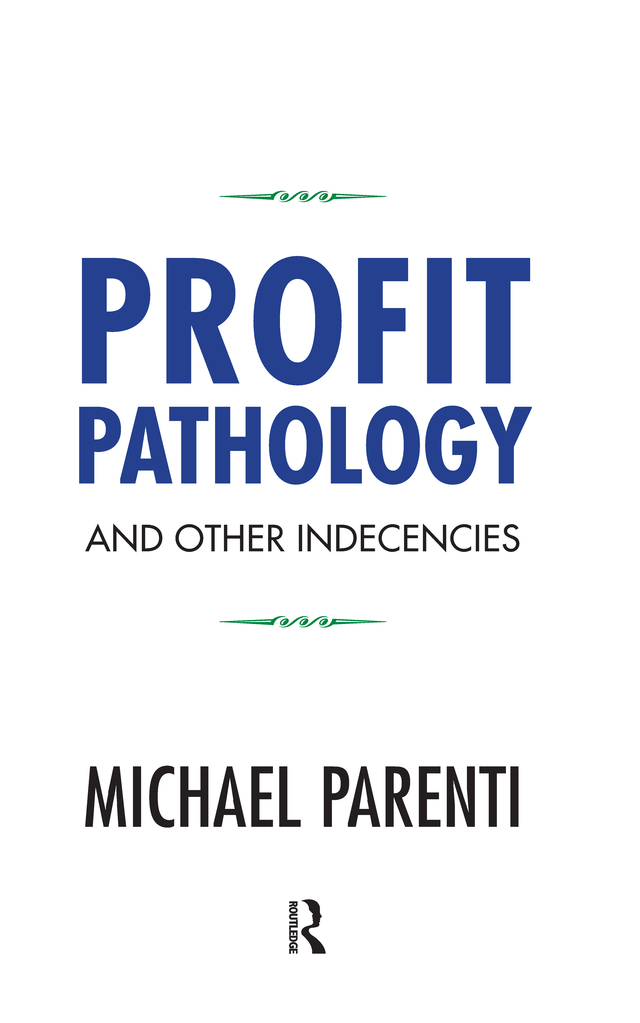
Profit Pathology and Other Indecencies From market crisis to market boom, from welfare to wealth care, from homelessness to helplessness, and an all-out assault on the global environment-these are just some of the indecencies of contemporary economic life that Profit Pathology takes on. Here, Michael Parenti investigates how class power is a central force in our political life and, yet, is subjected to little critical discernment. He notes how big-moneyed interests shift the rules of the game in their favor while unveiling the long march by reactionaries through the nation's institutions to undo all the gains of social democracy, from the New Deal to the present. Parenti also traces the exploitative economic forces that have operated through much of American history, including the mass displacement and extermination of Native Americans and the enslavement of Africans. Parenti is a master at demonstrating the impact of monomaniacal profit accumulation on social services-especially health care-and human values. Here he takes us one step further, showing how unrestrained capitalism ultimately endangers itself, becoming a "self-devouring beast" that threatens us all. Finally, he calls for a solution based on democratic diversity and public ownership-"because it works." POLITICAL SCIENCE,General
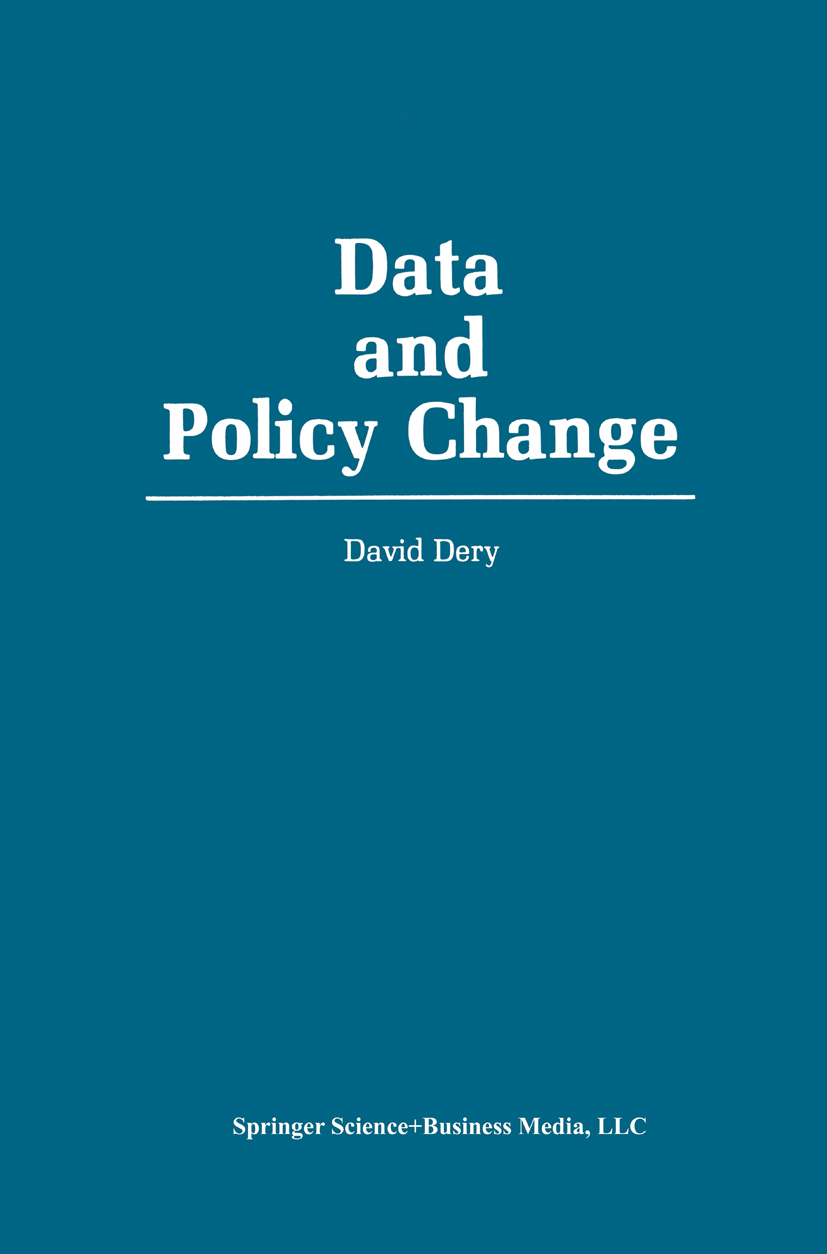
Data and Policy Change This is a work on "hostile" data and the conditions under which they are accepted and rejected. What is the place of data in politics and organization? Why are politicians and administrators so often hostile to research data, or why do they tend to perceive data as hostile to them? How can data become relevant to policy? These questions are the focus of this book. In answer I try to show how political and administrative institutions cope with "hostile" data; how they seek to maintain closedness to disconfirming data, and how they are led, in a free society, to change their policies despite the epistemological bias in favor of the already known and the initial inclination to resist change. At the same time, I demonstrate that data producers must learn that while their research findings may be subjected to science's own standards of verifiability, such data must also meet standards of contestability by the various interests involved in political and administrative decisions. The production and "appropriate" publication of a research report may at best buy one an admission ticket to participate in political and administrative contests, but not the power nor the justification to determine the outcomes of the contest. I begin with two hypotheses: Hypothesis 1: Politicians or administrators reject data that do not coincide with behavior they are unwilling to change. Hypothesis II: Politicians or administrators change behavior that does not coincide with data they are unwilling to reject. POLITICAL SCIENCE,General
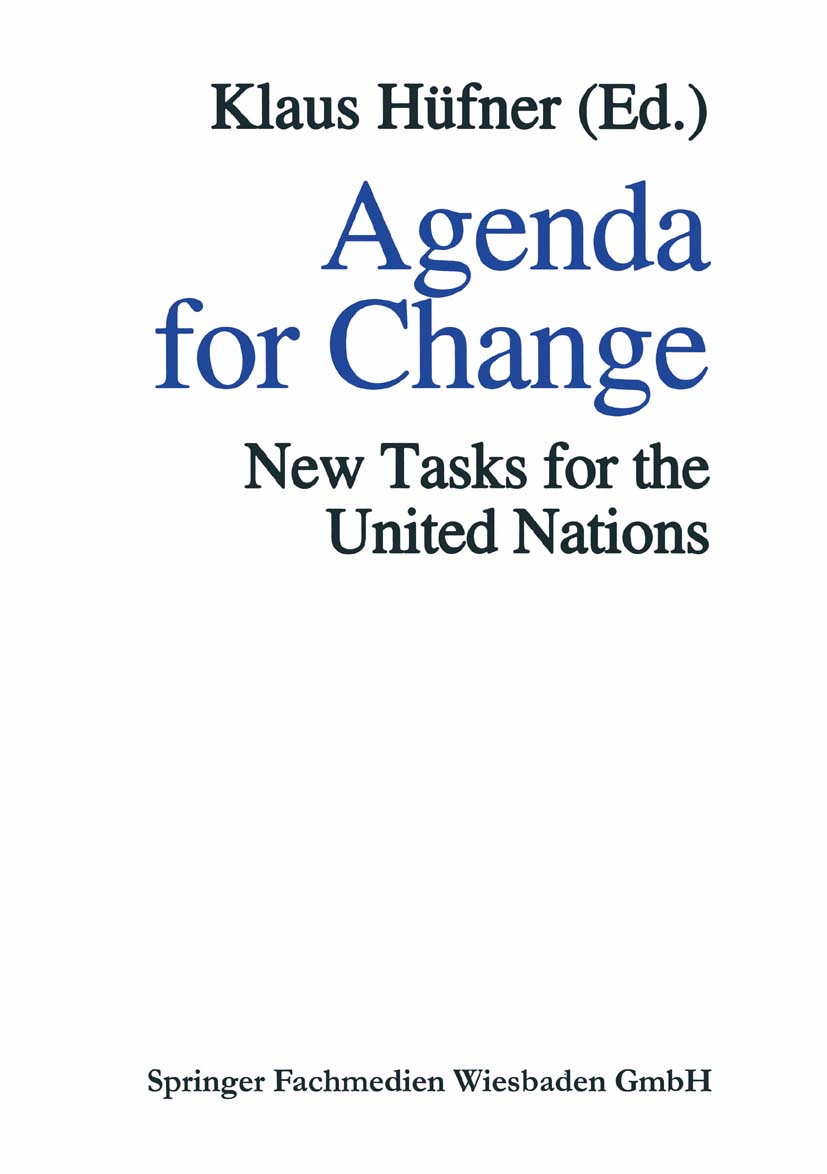
Agenda for Change The 50th anniversary of the United Nations Organisation is commemorated in 1995. The UN emerged at the end of the most bloody war in the history of contemporary civilization and it is understandable that its founding fathers were concerned first and foremost with the need "to save succeeding gen erations from the scourge of war." This great historical mission of the new international organisation was determined and designed by the allied powers that had won the war against the "enemy states." Cooperation of the perma nent members of the UN Security Council was the basic element of the effi ciency of post -war system of international peace and security. Apart from this main mission, the founding fathers of the United Nations declared their determination "to reaffirm faith in fundamental human rights, in the dignity and worth of the human person, in the equal rights of men and women and of nations large and small, and to establish conditions under which justice and respect for the obligations arising from treaties and other sources of international law can be maintained, and to promote social prog ress and better standards of life in larger freedom" (preamble, UN Charter). POLITICAL SCIENCE,General
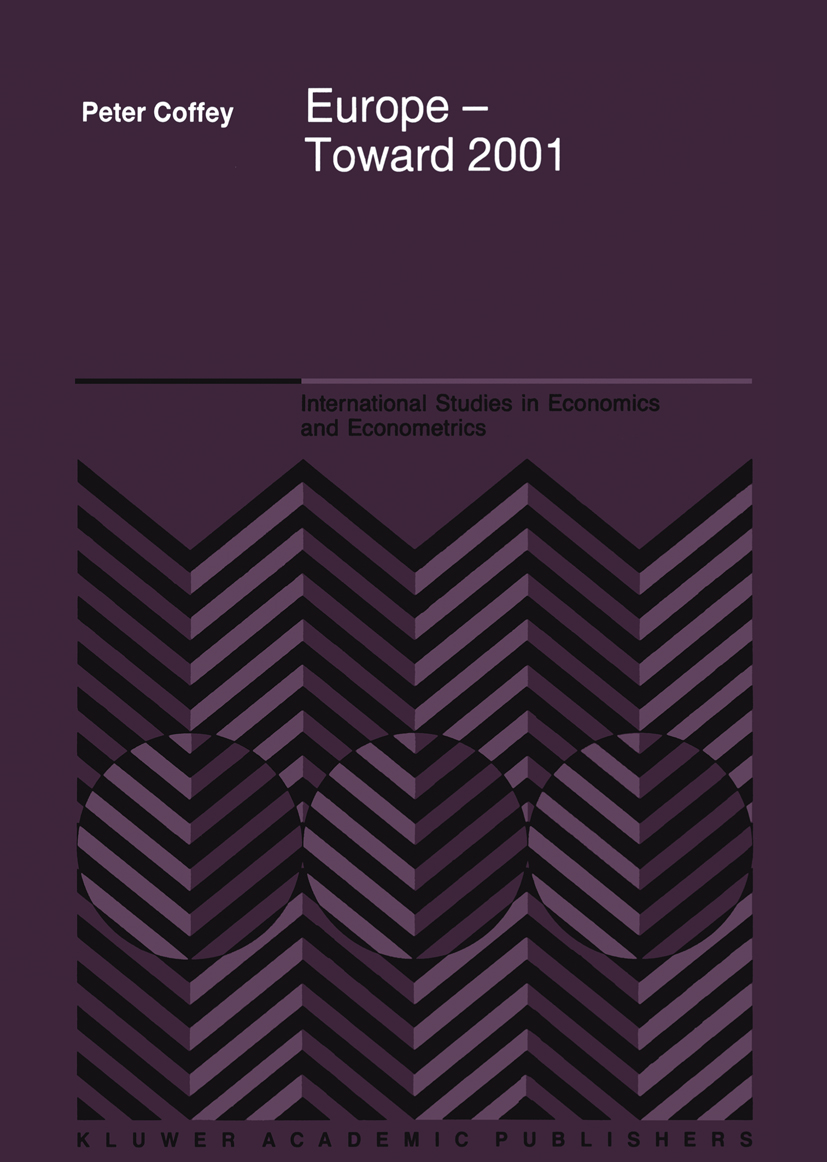
Europe — Toward 2001 THEBACKGROUND Why a book on Europe - Toward the Year 200l? There are two principal reasons why a European should embark upon such a hazardous enterprise. First, when the Treaty on European Union (popularly known as the Maastricht Treaty, and, hereafter referred to as the Treaty in this introduction) was signed in February 1992, it was agreed that the heads of government of the EU Member States would assemble, in 1996, to examine its workings. This meeting will be known as the Intergovernmental Conference (IGC). Second, by the end of the century, it is certain that arrangements will have been made for the admission of some countries of Central and Eastern Europe into the European Union (EU). Consequently, even with or without the holding of the IGC, it will be urgently necessary to reform some of the Community's policies - notably the Common Agricultural Policy (CAP) and the structural poliCies which are linked, for example, 2 Europe - Toward 2001 with the Regional and Social Funds - before these countries become members. Failure to do this could result in bankruptcy for the EU. Of almost equal importance is the reform of the institutions and the actual workings of the Community. Already with 12 Member States, it was difficult enough to manage things on a daily basis. Now, as more countries join the Union, things could literally grind to a stop. Thus, changes in this area are indispensable. POLITICAL SCIENCE,General

Drugs, Power, and Politics This book explores the increasingly broad terrain of drugs in American society with an emphasis on politics. It begins with the War on Drugs initiated by President Richard Nixon in the early 1970s and extends to the current day with the vast power of the pharmaceutical industry (Big Pharma), expansion of global criminal syndicates, militarization of the drug war, and struggles between states and federal government over the legalization of marijuana. From the beginning, the drug war produced increasing authoritarian tendencies in American politics, visible not only in swollen national bureaucracies and burgeoning police functions, but in the rise of the largest prison-industrial complex in the world, a surveillance state, and the weakening of personal privacy and freedoms. At the same time, the legal drug system with some of the most profitable business operations anywhere has expanded to create a huge medical edifice, affecting the delivery of health care, development of modern psychology, evolution of the treatment industry, and many other areas of contemporary life, including the world of sports and recreation. Although prohibitionism remains very much alive, targeting a wide range of illicit drugs, today it is the hundreds of widely-marketed chemical substances sold by Big Pharma that result in some of the most serious health problems affecting society. This book explores the long historical trajectory of both the War on Drugs and the growth of Big Pharma, focusing on social outcomes and political consequences in the US and beyond. POLITICAL SCIENCE,General
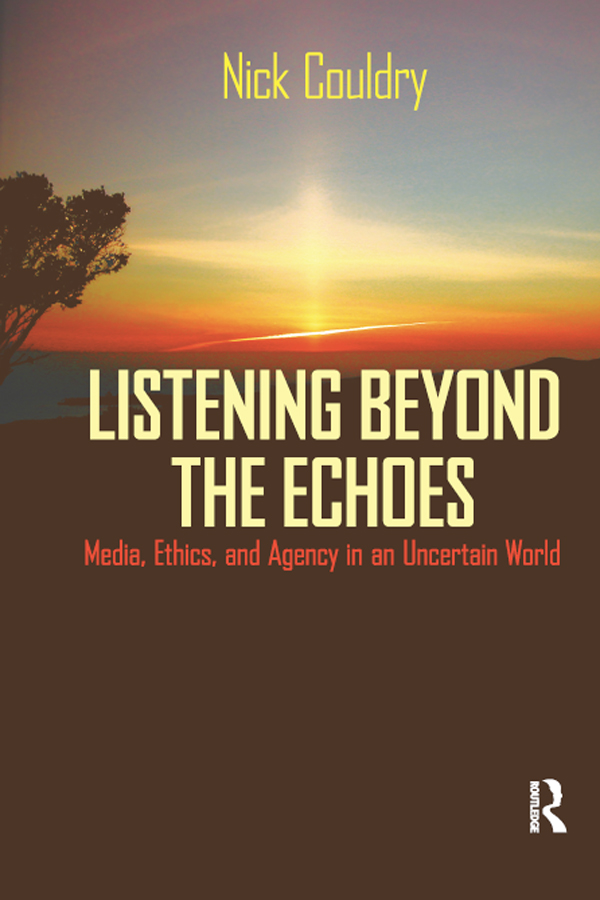
Listening Beyond the Echoes In this book Nick Couldry, media and cultural theorist from the London School of Economics, asks what are the priorities for media and cultural research today - at a time of the intensified mediation of all fields of social life, threats to democratic legitimacy, and serious instability on the global political stage. The book calls for a "decentered" media research that rejects easy assumptions about media's role in holding societies together and instead looks more critically at the difference media make on the ground to the material conditions of our lives. In what detailed ways do media transform knowledge and agency in daily life? How do media contribute to the culture of democratic politics? And, most difficult of all, how can we live, ethically, with and through media? Couldry's previous work is well known for its breadth, ranging across media sociology, media theory and cultural theory. Here he draws also on political theory and ethics to develop a tightly-argued account of how media and cultural research must now reorient itself if it is to remain relevant and critical. Nick Couldry is Reader in Media, Communications and Culture at the London School of Economics and Political Science. He is the author or editor of five books including Media Rituals: A Critical Approach (Routledge 2003), The Place of Media Power (Routledge 2000) and (coedited with James Curran) Contesting Media Power (Rowman and Littlefield 2003). POLITICAL SCIENCE,General

British Politics Over the last two decades British politics has undergone a remarkable transformation. While some components of the system have been eroded, such as voter turnout and membership of the big parties, other parts have flourished, such as nationalist parties, the insurgent UKIP, as well as the new media. British Politics: The Basics analyses these changes and places them within the context of the evolution of British society from absolute monarchy to representative democracy. It considers each of the major components of British politics, such as the Monarchy and the House of Lords, the Commons, voting behaviour, parties and pressure groups, the Prime Minister and Cabinet, devolution, local government, and foreign policy. Its contents include coverage of recent events such as the Scottish Referendum and the 2015 General Election. This readable and comprehensive introduction will be of key interest to A-level students, undergraduates and those new to the study of British politics. POLITICAL SCIENCE,General

Scientific, Environmental, and Political Issues in the Circum-Caspian Region Proceedings of the NATO Advanced Research Workshop on The Scientific, Environmental, and Political Issues of the Circum-Caspian Region, Moscow, Russia, 13-16 May 1996 POLITICAL SCIENCE,General
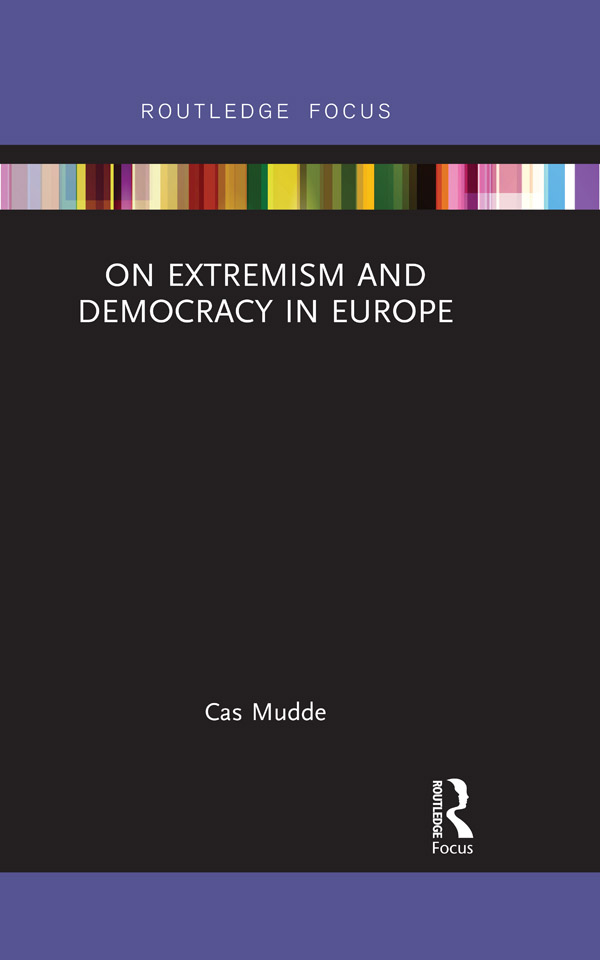
On Extremism and Democracy in Europe On Extremism and Democracy in Europe is a collection of short and accessible essays on the far right, populism, Euroscepticism, and liberal democracy by one of the leading academic and public voices today. It includes both sober, fact-based analysis of the often sensationalized "rise of the far right" in Europe as well as passionate defence of the fundamental values of liberal democracy. Sometimes counter-intuitive and always thought-provoking, Mudde argues that the true challenge to liberal democracy comes from the political elites at the centre of the political systems rather than from the political challengers at the political margins. Pushing to go beyond the simplistic opposition of extremism and democracy, which is much clearer in theory than in practice, he accentuates the internal dangers of liberal democracy without ignoring the external threats. This book is essential reading for anyone interested in European politics, extremism and/or current affairs more generally. POLITICAL SCIENCE,General

Can the Welfare State Survive? After the most serious economic crash since the 1930s and the slowest recovery on record, austerity rules. Spending on the welfare state did not cause the crisis, but deep cuts in welfare budgets has become the default policy response. The welfare state is seen as a burden on wealth creation which can no longer be afforded in an ever more competitive global economy. There are calls for it to be dismantled altogether. In this incisive book, leading political economist Andrew Gamble explains why western societies still need generous inclusive welfare states for all their citizens, and are rich enough to provide them. Welfare states can survive, he argues, but only if there is the political will to reform them and to fund them. POLITICAL SCIENCE,General
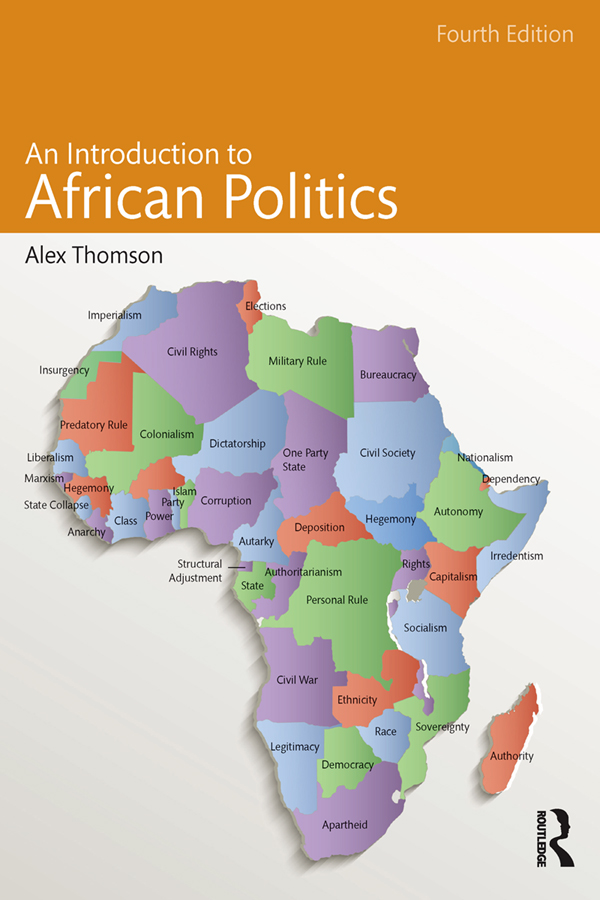
An Introduction to African Politics The fourth edition of An Introduction to African Politics is an ideal textbook for those new to the study of this fascinating continent. It gets to the heart of the politics of this part of the world. How is modern Africa still influenced by its colonial past? How do strong ethnic and religious identities on the continent affect government? Why has the military been so influential? How does African democracy differ from democracy in the West? These are the sorts of question tackled by the book. The result is a textbook that identifies the essential features of African politics, allowing students to grasp the recurring political patterns that have dominated this continent since independence. Key features include: Thematically organised, with individual chapters exploring issues such as colonialism, ethnicity, nationalism, religion, social class, ideology, legitimacy, authority, sovereignty and democracy. Identifies key recurrent themes such as the competitive relationships between the African state, its civil society and external interests. Contains useful boxed case studies at the end of each chapter, including: Kenya, Tanzania, Nigeria, Botswana, Côte d’Ivoire, Uganda, Somalia, Ghana, Democratic Republic of the Congo and Zimbabwe. Each chapter concludes with key terms and definitions, as well as questions and advice on further reading. This textbook is essential reading for students seeking an accessible introduction to the complex social relationships and events that characterise the politics of post-colonial Africa. POLITICAL SCIENCE,General
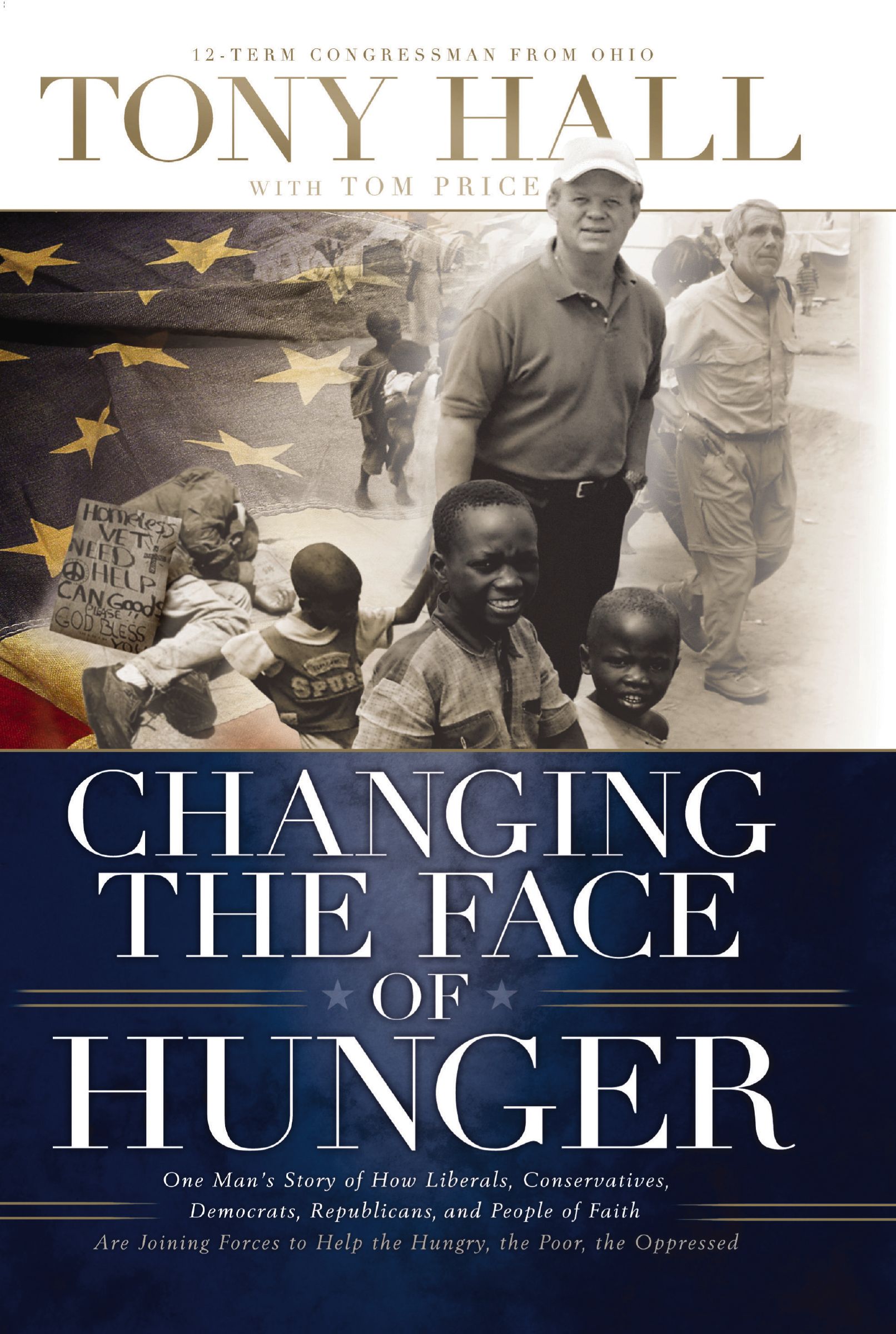
Changing the Face of Hunger If Tony Hall was to be true to his faith, he must find a way to bring God into the political world in which he worked. He realized, as he watched a doctor combing the crowds of starving Africans in Ethopia looking for a half-dozen lives he could save, that he would travel among the hungry and bring their needs to the attention of Washington. POLITICAL SCIENCE,General

Global Political Economy Praised for its authoritative coverage, Global Political Economy places the study of international political economy (IPE) in its broadest theoretical contextnow updated to cover the continuing global economic crisis and regional relationships and impacts. This text not only helps students understand the fundamentals of how the global economy works but also encourages them to use theory to more fully grasp the connections between key issue areas like trade and development. Written by a leading IPE scholar, this text equally emphasizes theory and practice to provide a framework for analyzing current events and long-term developments in the global economy. New to the Seventh Edition Focuses on the ongoing global economic crisis and the continuing European sovereign debt crisis, along with other regional economic issues, including their implications for relationships in the global economy. Offers fuller and updated discussions of critical perspectives like feminism and environmentalism, and includes new material differentiating among the terms neomercantilism, realism, mercantilism, and economic nationalism. Updated, author-written Test Bank is provided to professors as an e-Resource on the book’s Webpage. POLITICAL SCIENCE,General
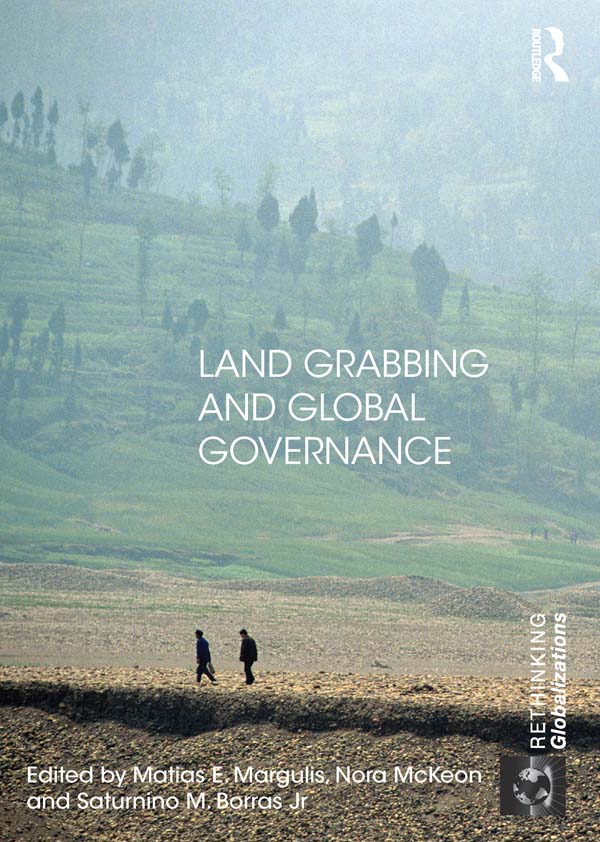
Land Grabbing and Global Governance Land grabbing per se is not a new phenomenon, given its historical precedents in the eras of imperialism. However, the character, scale, pace, orientation and key drivers of the recent wave of land grabs is a distinct historical event closely tied to the changing dynamics of the global agri-food, feed and fuel complex. Land grabbing is facilitated by ever greater flows of capital, goods, and ideas across borders, and these flows occur through axes of power that are far more polycentric than the North-South imperialist tradition. Land grabs occur in the context of changes in the character of the global food regime, formerly anchored by North Atlantic empires; the integrated food-energy complex seems to be headed towards multiple centres of power, especially with the rise of the BRICS and the proliferation of middle income countries participating in many of the land transactions. Land Grabbing and Global Governance offers insights from leading scholars and experts on contemporary land grabs. This volume examines land grabs in direct relation to a global economy undergoing profound change and the role of new configurations of actors and power in governance institutions and practices. This book was published as a special issue of Globalizations. POLITICAL SCIENCE,General
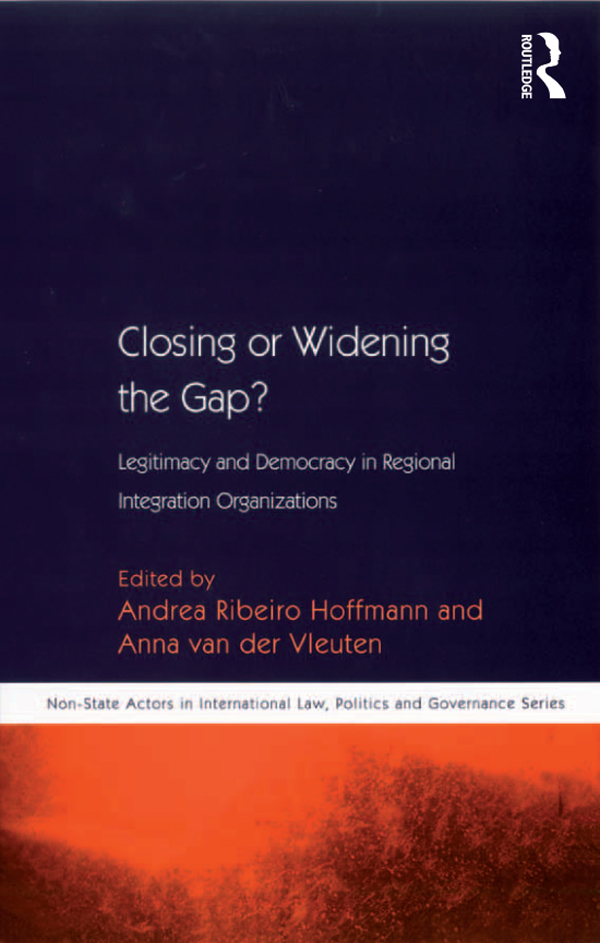
Closing or Widening the Gap? Combining normative analysis and theory-driven empirical research in a comparative framework, this volume clarifies and explains the connections between regional international governance, legitimacy and democracy. It focuses on the quality of democracy and the legitimacy of policy making in multilevel regional systems. The volume offers a much-needed clarification of confusing concepts such as legitimacy, democracy and 'civil society' in non-national political systems. It critically assesses the quality of democracy and legitimacy within different Regional International Organizations (RIOs); it examines how networks of non-state actors become a kind of transnational civil society and assesses their potential for solving legitimacy deficits; and it investigates the impact of democratic conditionality in different RIOs. The contributors deepen our understanding of a relatively new non-state actor on the international scene - the regional international organization - and investigate the potential contribution of transnational non-state actors to the quality of governance at the regional level. POLITICAL SCIENCE,General
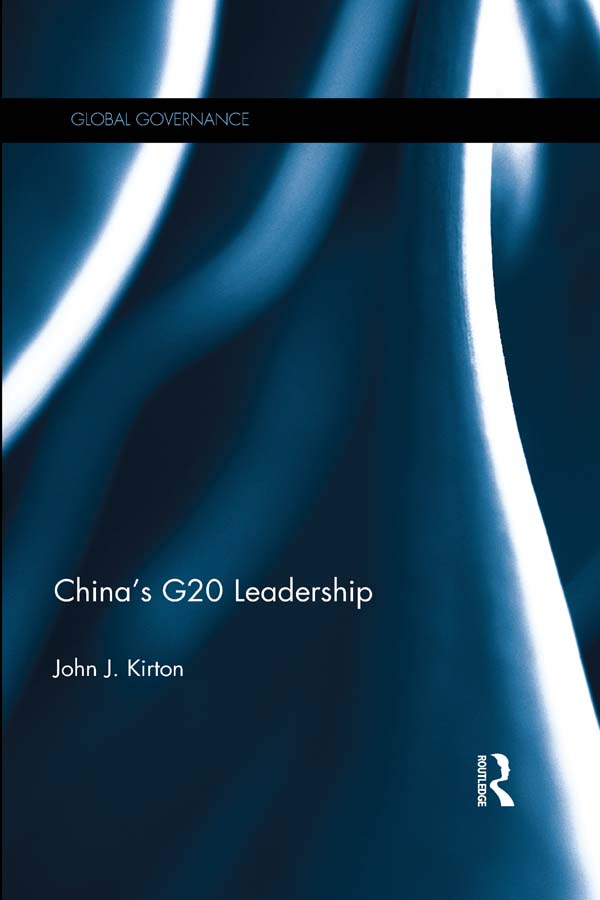
China’s G20 Leadership Kirton offers a comprehensive, systematic examination of China’s G20 approach, diplomacy and influence since the G20’s start as a forum for finance ministers and central bankers in 1999. This comprehensive reference tool works its way through China’s elevation to the leaders’ level with summits from 2008-2014, to the prospects for its Antalya Summit in November 2014 and above all China’s first summit as host in Hangzhou in the autumn of 2016. This book contains a full treatment of China’s role in the summits from 2011 to 2014, and China’s plans, role and prospects for the summits in 2015 and 2016. Analytically, it develops and tests at the level of a single member country the systemic hub model of G20 governance that was developed for and guided in Kirton’s 2013 book, G20 Governance for a Globalized World. POLITICAL SCIENCE,General
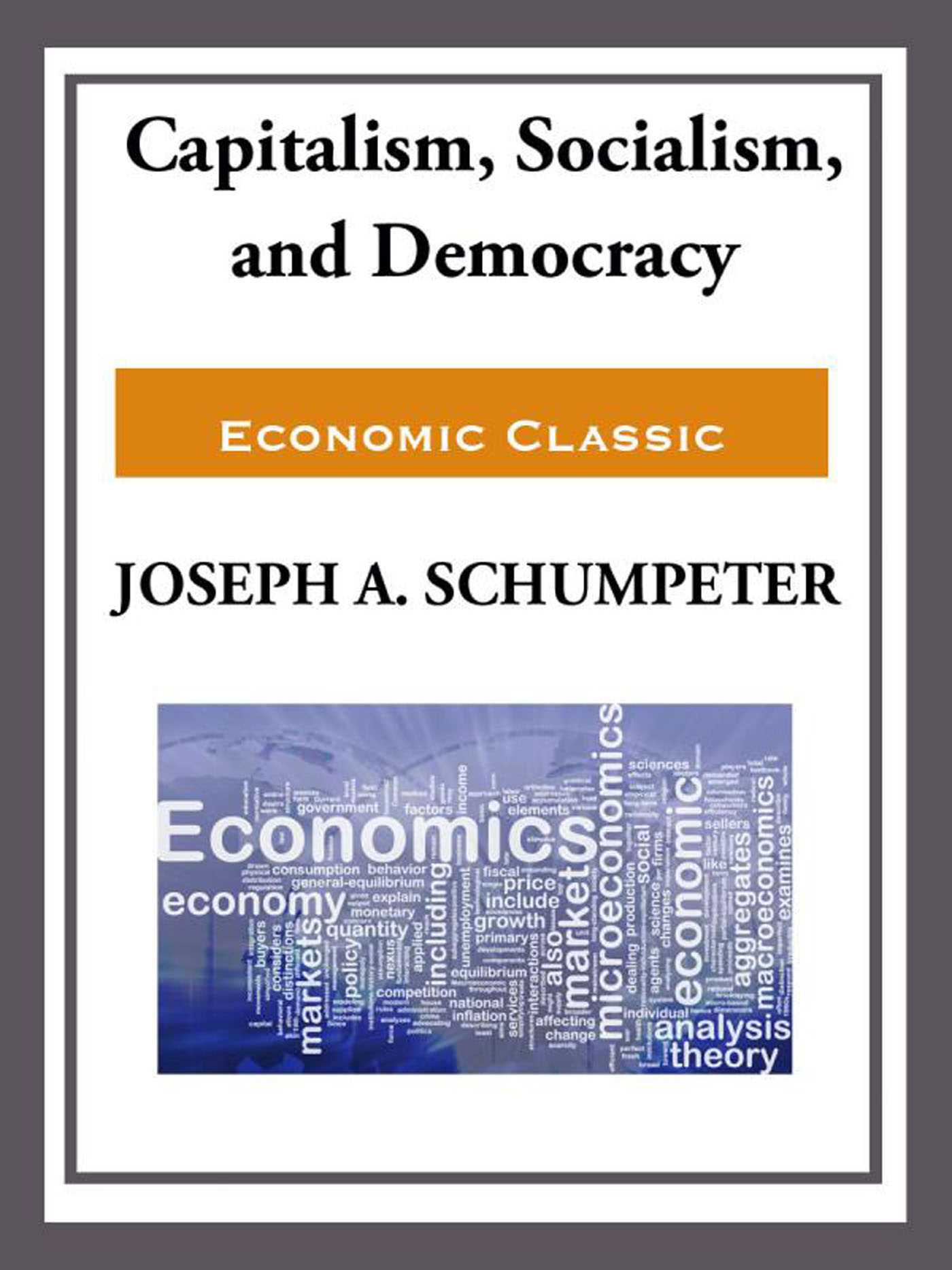
Capitalism, Socialism, and Democracy Capitalism, Socialism and Democracy remains one of the greatest works of social theory written this century. When it first appeared the New English Weeklypredicted that `for the next five to ten years it will cetainly remain a work with which no one who professes any degree of information on sociology or economics can afford to be unacquainted.' Fifty years on, this prediction seems a little understated. POLITICAL SCIENCE,General
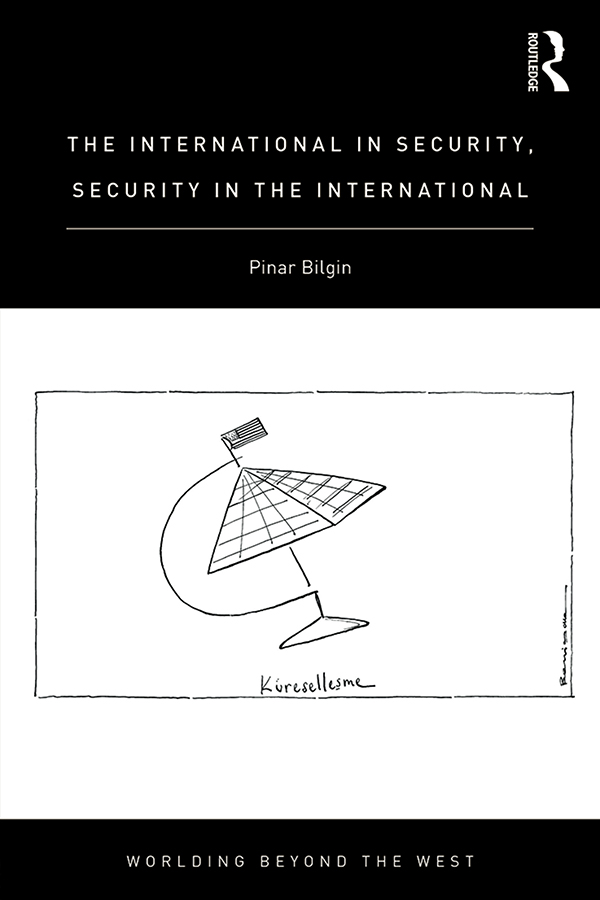
The International in Security, Security in the International International Relations continues to come under fire for its relative absence of international perspectives. In this exciting new volume, Pinar Bilgin encourages readers to consider both why and how ‘non-core’ geocultural sites allow us to think differently about key aspects of global politics. Seeking to further debates surrounding thinking beyond the 'West/non-West' divide, this book analyzes how scholarship on, and conceptions of, the international outside core contexts are tied up with peripheral actors’ search for security. Accordingly, Bilgin looks at core/periphery dynamics not only in terms of the production of knowledge in the production of IR scholarship, or material threats, but also peripheral actors' conceptions of the international in terms of 'standard of civilization' and their more contemporary guises, which she terms as ‘hierarchy in anarchical society’. The first three chapters provide a critical overview of the limits of ‘our’ theorizing about IR and security, as well as a discussion on the track record of critical approaches to IR and security in addressing those limits. The following three chapters offer one way of addressing the limits of ‘our’ theorizing about IR and security: by inquiring into the international in security, security in the international. Each of these chapters makes a theoretical point and illustrates this further in a spotlight section that further illustrates the point to aid student learning. A genuinely innovative contribution to this rapidly emerging field within IR, this book is essential reading for students and scholars of critical security, international relations theory and Global IR. POLITICAL SCIENCE,General
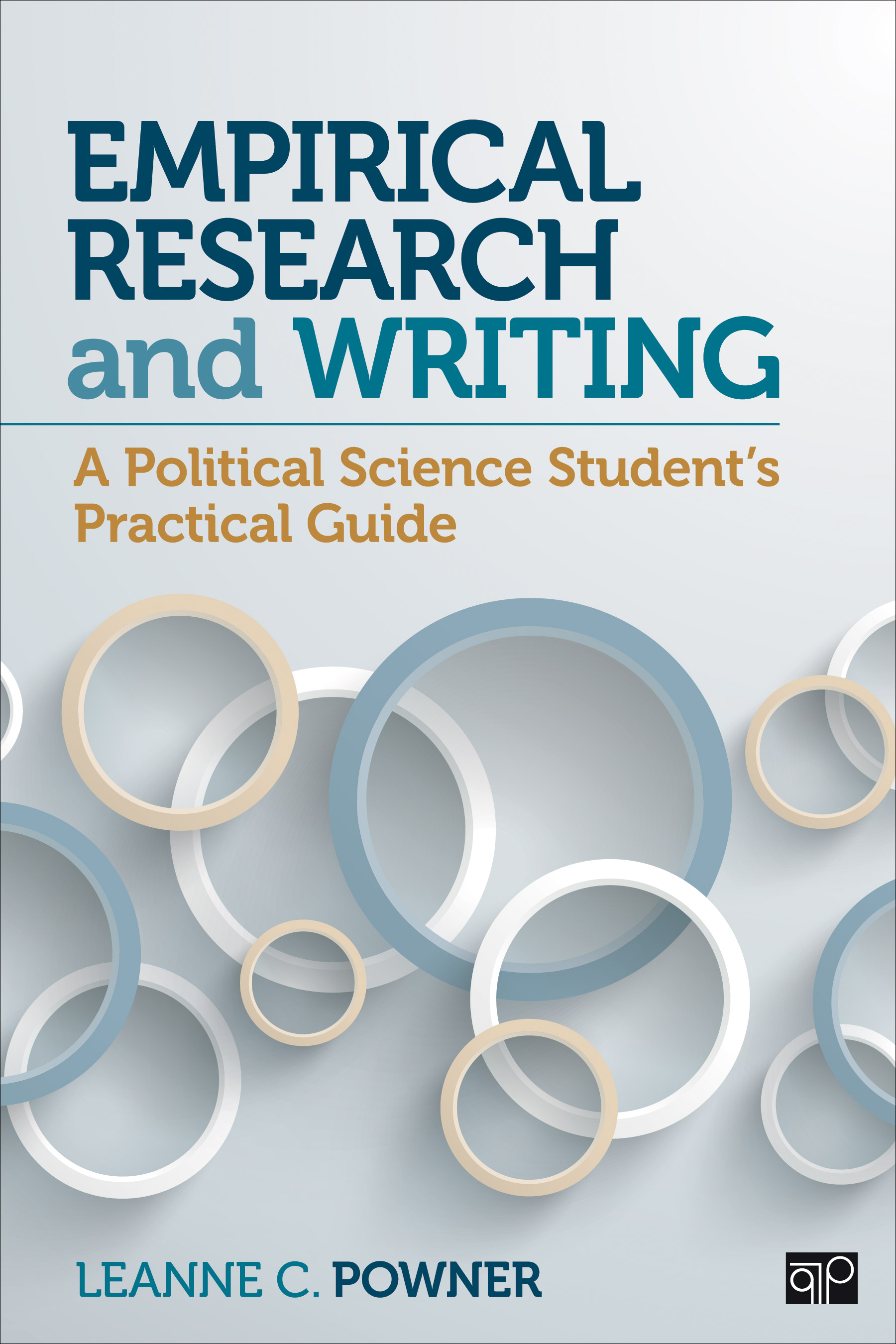
Empirical Research and Writing Students can easily misstep when they first begin to do research. Leanne C. Powner’s new title Empirical Research and Writing: A Student's Practical Guide provides valuable advice and guidance on conducting and writing about empirical research. Chapter by chapter, students are guided through the key steps in the research process. Written in a lively and engaging manner and with a dose of humor, this practical text shows students exactly how to choose a research topic, conduct a literature review, make research design decisions, collect and analyze data, and then write up and present the results. The book's approachable style and just-in-time information delivery make it a text students will want to read, and its wide-ranging and surprisingly sophisticated coverage will make it an important resource for their later coursework. POLITICAL SCIENCE,General
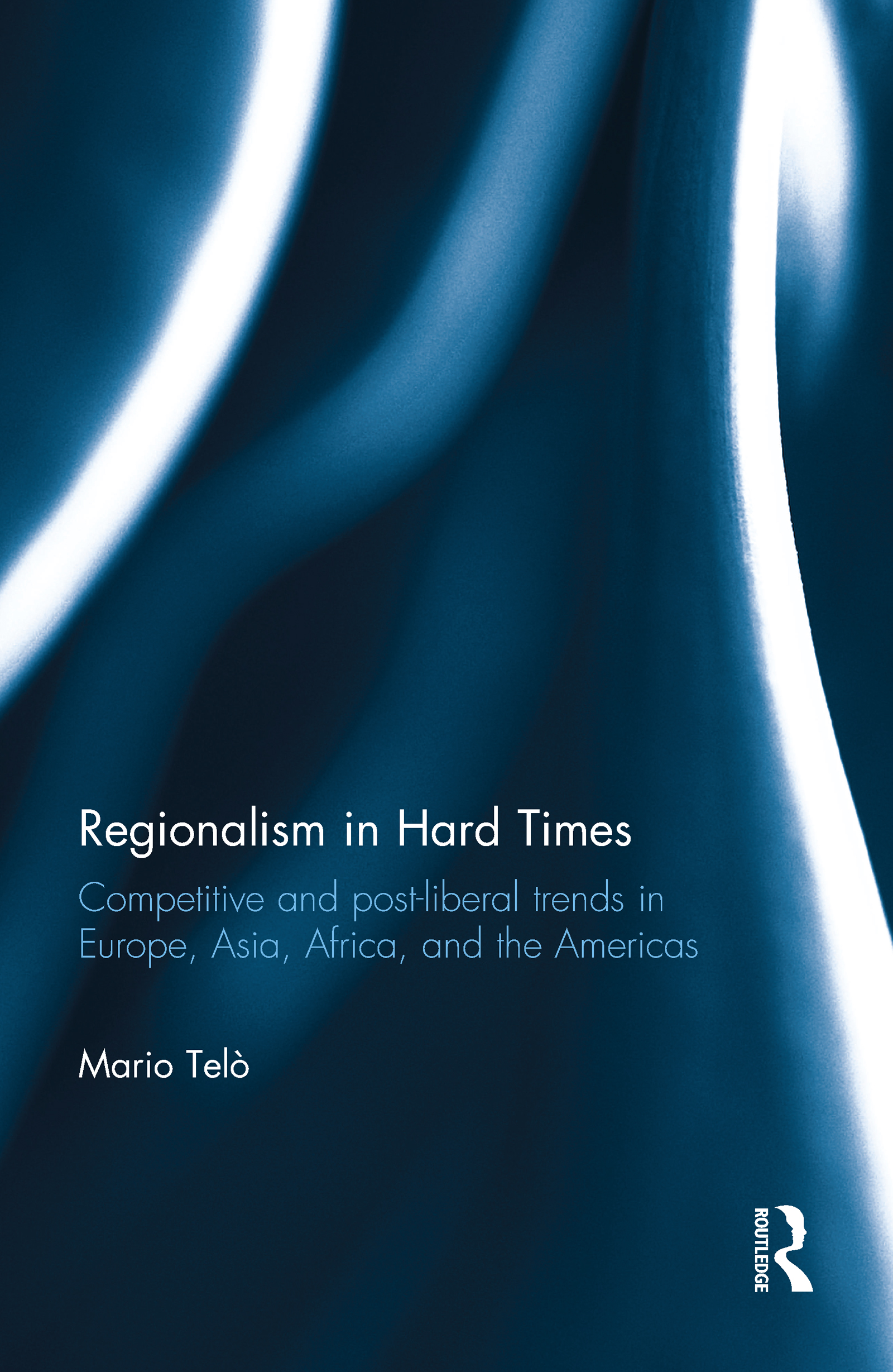
Regionalism in Hard Times Brexit confirms that the EU is not a super-state in the making but rather an advanced regional organization. This book bridges the gap between EU studies and international relations by providing a student-friendly presentation of regional, multidimensional cooperation among neighbouring states and societies, its four epochs and relevant variations and similarities across five continents, its interplay with globalization, and the changing post-hegemonic and post-Cold War international order. This text secondly focuses on the question of regionalism in hard times: whether the global financial crisis and multipolar power politics are leading to more competitive and political forms of instrumental regionalism and interregionalism in Europe, East-Asia and the Americas. It does this by addressing the political and strategic dimensions of changing regional/interregional arrangements and their current and potential impact on global governance, notably on trade and security challenges. POLITICAL SCIENCE,General
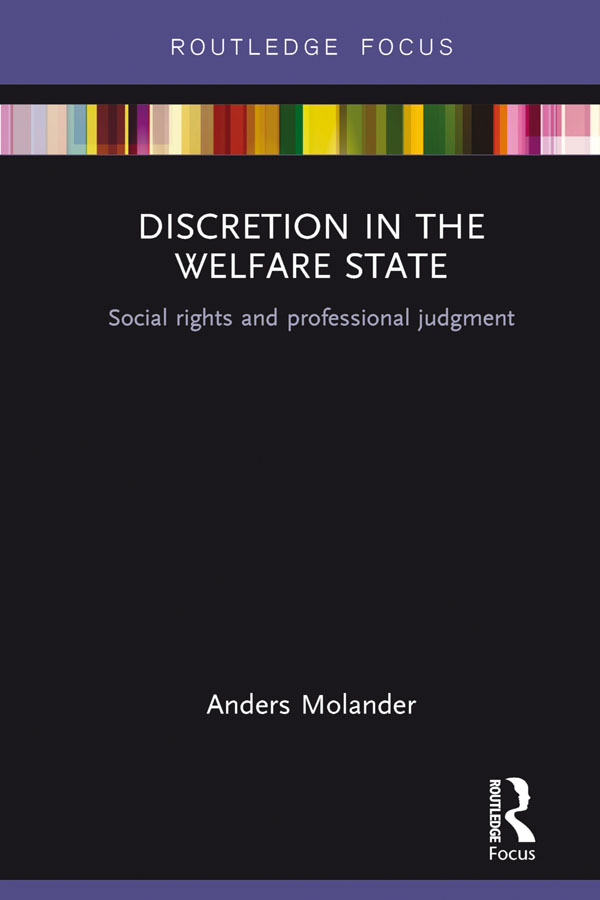
Discretion in the Welfare State Welfare state professionals decide or establish premises as to whom will receive what, in what manner, when and how much, and when enough is enough. They control who passes through the gates of the welfare state. This book provides an in-depth understanding of the phenomenon of discretion. It shows why the delegation of discretionary powers to professionals in the front-line of the welfare state is both unavoidable and problematic. Extensive use of discretion can threaten the principles of the rule of law and relinquish democratic control over the implementation of laws and policies. The book introduces an understanding of discretion that adds an epistemic dimension (discretion as a mode of reasoning) to the common structural understanding of discretion (an area of judgment and decision). Accordingly, it distinguishes between structural and epistemic measures of accountability. The aim of the former is to constrain discretionary spaces or the behavior within them while the aim of the latter is to improve the quality of discretionary reasoning. This text will be of key interest to scholars and students in the fields of applied philosophy, public policy and public administration, welfare state research, and the sociology of professions. POLITICAL SCIENCE,General

Military Neuroscience and the Coming Age of Neurowarfare Krishnan describes military applications of neuroscience research and emerging neurotechnology with relevance to the conduct of armed conflict and law enforcement. This work builds upon literature by scholars such as Moreno and Giordano and fills an existing gap, not only in terms of reviewing available and future neurotechnologies and relevant applications, but by discussing how the military pursuit of these technologies fits into the overall strategic context. The first to sketch future neurowarfare by looking at its potentials as well as its inherent limitations, this book’s main theme is how military neuroscience will enhance and possibly transform both classical psychological operations and cyber warfare. Its core argument is that nonlethal strategies and tactics could become central to warfare in the first half of the twenty-first century. This creates both humanitarian opportunities in making war less bloody and burdensome as well as some unprecedented threats and dangers in terms of preserving freedom of thought and will in a coming age where minds can be manipulated with great precision. POLITICAL SCIENCE,General
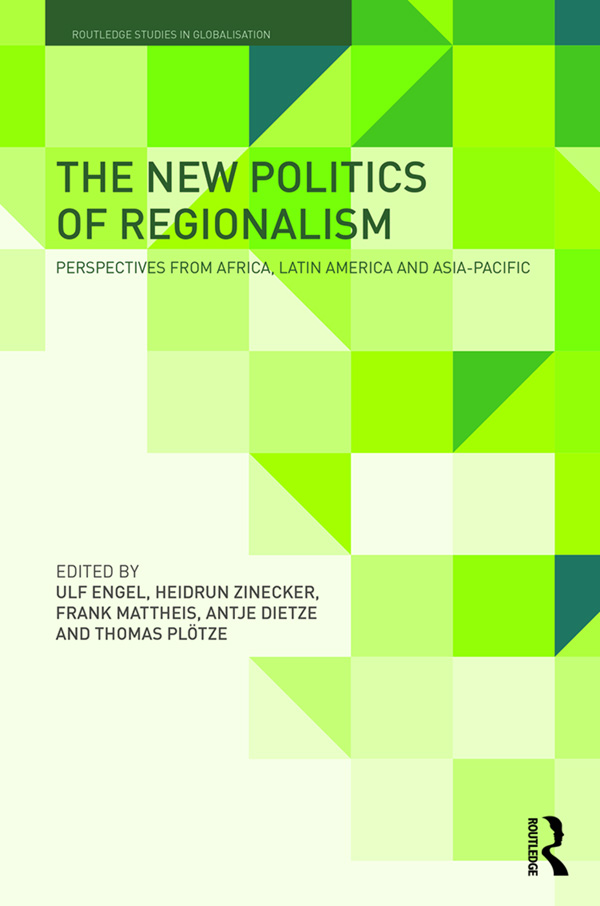
The New Politics of Regionalism This edited volume approaches regionalism as one potential pattern in a changing global order. Since the end of the Cold War, different forms of territorialization have emerged and we are confronted with an increasing number and variety of actors that are establishing regional projects. This volume offers an innovative contribution to the study of this new complexity by exploring constellations of regional actors, spatial scales and imaginations beyond state-centred perspectives as well as on multiple, often overlapping levels. The chapters analyse the emergence, trajectories and outcomes of regionalisms from the perspective of the Global South, specifically concentrating on regional projects in Latin America and Africa, but also in the Asia-Pacific. They attempt to identify the specific conditions and junctures of different forms of region-making in their external (global) and internal (local/national) dimensions. The volume also places special emphasis on interactions, spatial entanglements and comparisons between regionalisms in different parts of the world. By expanding beyond the perspective of North-South transfers, this book seeks to better understand the dynamics and diversity of interregional interactions. This volume will appeal to scholars of global studies, international political economy, international relations, human geography, and development studies, as well as area studies specialists who focus on Latin America and Africa. POLITICAL SCIENCE,General
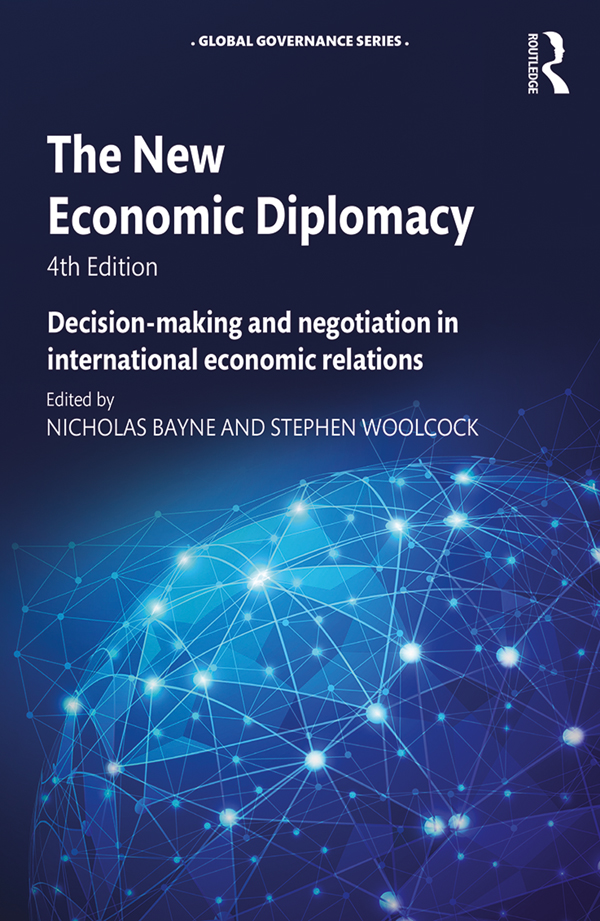
The New Economic Diplomacy The New Economic Diplomacy explains how states conduct their external economic relations in the 21st century: how they make decisions domestically, how they negotiate internationally and how these processes interact. Although the previous edition, published in 2011, was able to reflect the impact of the financial crisis and the immediate reaction to it, a lot has happened since then, and the atmosphere of economic diplomacy has darkened. To capture the emergence of new trends and the intensification of old ones, the salient features of this new edition are: The advance of China and other emerging powers at the expense of G7 governments, despite some setbacks; Much greater activity in negotiating regional and plurilateral trade agreements, while the multilateral system struggles; The persistence of problems exposed by the financial crisis, notably the long-running euro-zone crisis. The interaction between domestic and external forces: the balance has shifted towards the domestic axis, with international agreement more difficult to achieve. This edition goes further in comparing the practice of different players, to reflect the greater diversity of economic diplomacy. Based on the authors' work in the field of International Political Economy, it is suitable for students interested in the decision-making processes in foreign economic policy, including those studying international relations, government, politics and economics. It will also appeal to politicians, bureaucrats, business people, NGO activists, journalists and the informed public. POLITICAL SCIENCE,General

Environmental Politics and Policy in the West, Third Edition Population growth, industrial development, and renewed resource extraction have put the wide-open spaces and natural resources that define the West under immense stress. Vested interests clash and come to terms over embattled resources such as water, minerals, and even open space. The federal government controls 40 to 80 percent of the land base in many western states, so its sway over the future of the West’s communities and environments has prompted the development of unique policies and politics. In the third edition of Environmental Politics and Policy in the West, Zachary A. Smith and John Freemuth bring together a roster of top scholars to explicate the key issues involved. The volume has been completely updated to cover rapidly changing developments in the West, including climate change, land management politics and policy, science controversies, western water and river restoration, tribal sovereignty issues, the management of endangered species, and renewable energy development. Contributors also address how bureaucracy and politics shape environmental dialogues and explore multifaceted issues such as the politics of dam removal and restoration, wildlife resource concerns, suburban sprawl and smart growth, the management of renewable resources, public land reform and science, tribal sovereignty and energy, and the allocation of the West’s tightly limited water resources. This timely new edition offers a comprehensive and current survey of influential western policy and environmental issues. It will be of great use to students of environmental studies and also public and environmental policy, as well as activists and professionals working in the environmental arena. Contributors: Leslie R. Alm, Esther Babcock, Hugh Bartling, Matthew A. Cahn, Charles Davis, Sandra Davis, Megan M. DeMasters, Duran Fiack, Robert E. Forbis Jr., John Freemuth, Sheldon Kamieniecki, Matt Lindstrom, Jean C. Mangun, William R. Mangun, Denise McCain-Tharnstrom, Daniel McCool, Zachary A. Smith POLITICAL SCIENCE,General
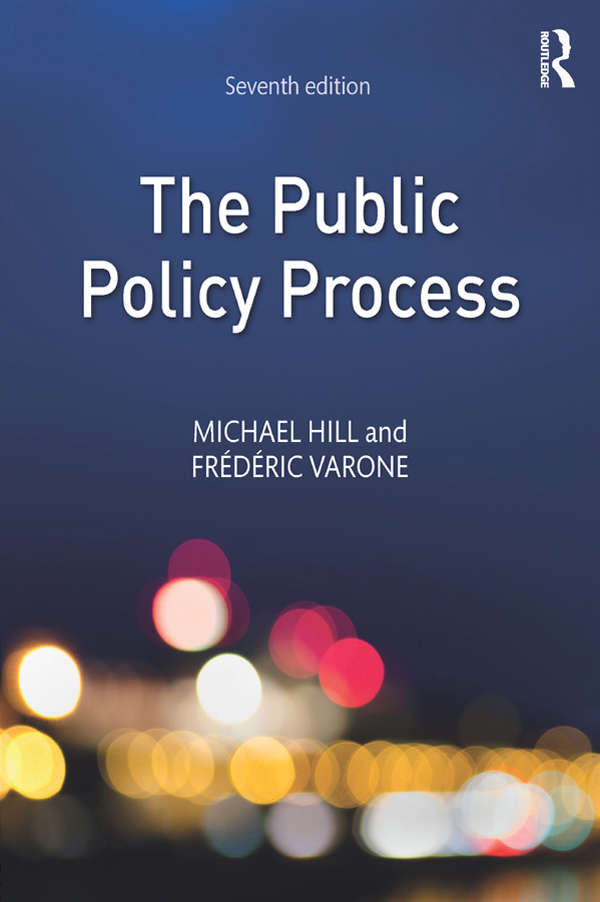
The Public Policy Process The Public Policy Process is essential reading for anyone trying to understand the process by which public policy is made. Explaining clearly the importance of the relationship between theoretical and practical aspects of policy-making, the book gives a thorough overview of the people and organisations involved in the process. Fully revised and updated for a 7th edition, The Public Policy Process provides: Clear exploration, using many illustrations, of how policy is made and implemented. A new chapter on comparative theory and methods. New material on studying advocacy coalitions, policy changes, governance, and evaluation. More European and international examples. This edition appears at a time when its concern to emphasise the complex implications of modern ‘governance’, and the way in which the ultimate outcome of a new policy initiative will depend on policy formulation and implementation processes, is particularly relevant to the UK government’s efforts to leave the European Union. POLITICAL SCIENCE,General
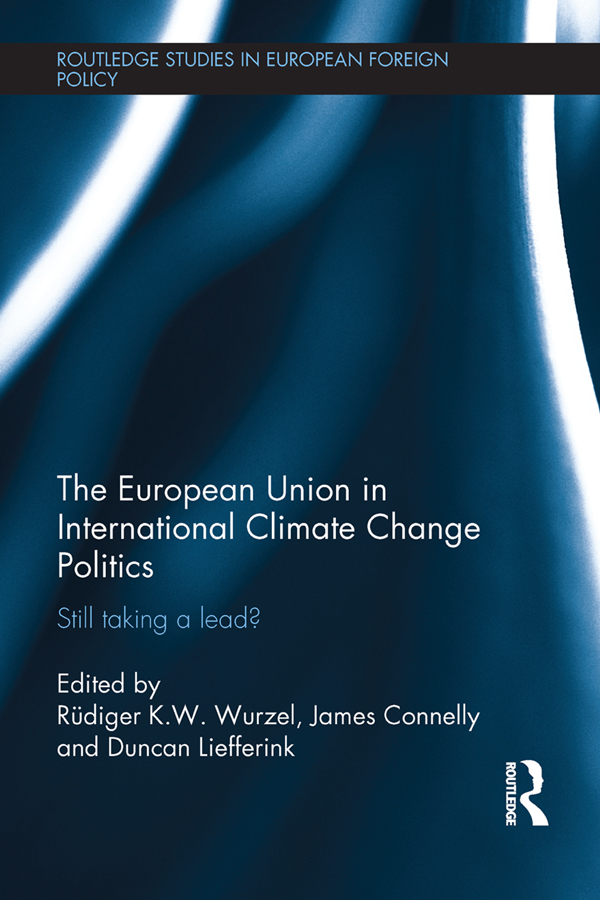
The European Union in International Climate Change Politics In recent years climate change has emerged as an issue of central political importance while the EU has become a major player in international climate change politics. How can a ‘leaderless Europe’ offer leadership in international climate change politics - even in the wake of the UK’s Brexit decision? This book, which has been written by leading experts, offers a critical analysis of the EU leadership role in international climate change politics. It focuses on the main EU institutions, core EU member states and central societal actors (businesses and environmental NGOs). It also contains an external perspective of the EU’s climate change leadership role with chapters on China, India and the USA as well as Norway. Four core themes addressed in the book are: leadership, multilevel and polycentric governance, policy instruments, and the green and low carbon economy. Fundamentally, it asks why we have EU institutional actors, why certain member states and particular societal actors tried to take on a leadership role in climate change politics and how, if at all, have they managed to achieve this? This text will be of key interest to scholars, students and practitioners in EU studies and politics, international relations, comparative politics and environmental politics. POLITICAL SCIENCE,General

The European Union's Africa Policies The European Union (EU) is a key partner for African regional organizations and a major promoter of economic and political integration in the region. Several studies have interpreted the EU's role in Africa as either a self-interested hegemonic actor or as a value oriented normative power. In this volume, Daniela Sicurelli challenges these views by taking a closer look at Europe's policies towards Sub-Saharan Africa in the area of peacekeeping, trade and development, and environmental protection. Using fresh empirical evidence, including interviews with both European and African officials, she argues that the EU is far from becoming a unitary player in Africa. Lacking a clear strategy and coherent normative framework, the EU should be considered a multi-level actor, where national and supranational institutions have different interests and push forward contrasting views of what role Europe should play in Africa. The ability of single institutions to frame an issue as requiring either intergovernmental or supranational procedures appears crucial for shaping the content of European Africa policies. An original contribution to the growing literature on the EU as an international actor, this book is extremely useful to scholars, researchers and policy-makers demanding critical work in the field of EU-Africa policy. POLITICAL SCIENCE,General
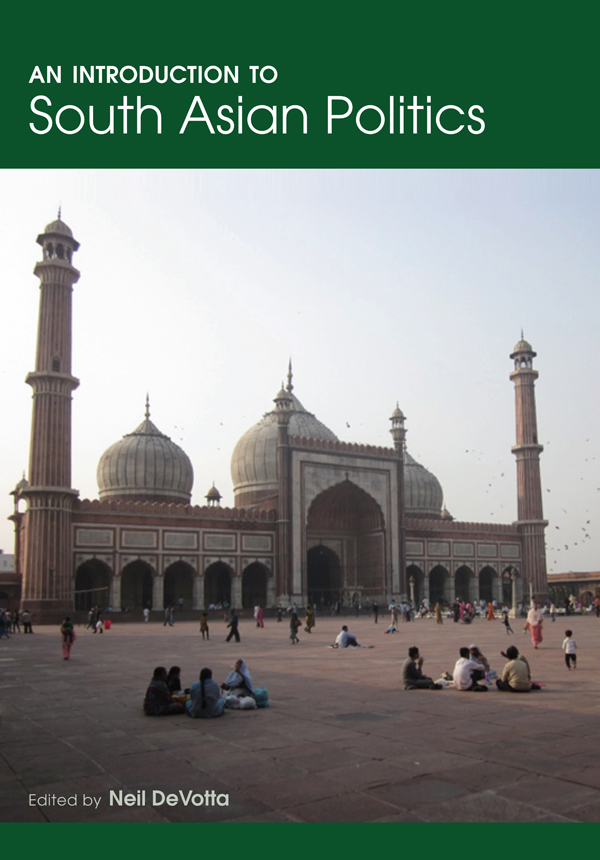
An Introduction to South Asian Politics This introductory textbook provides students with a fundamental understanding of the social, political, and economic institutions of six South Asian countries: Afghanistan, Bangladesh, India, Nepal, Pakistan, and Sri Lanka. It adopts a broad theoretical framework and evaluates the opportunities and constraints facing South Asia’s states within the context of democracy. Key features include: An introduction to the region. The history and political development of these South Asian states, including evaluations of their democratic trajectories. The management of conflict, economic development, and extremist threats. A comparative analysis of the states. Projections concerning democracy taking into consideration the opportunities and constraints facing these countries. This textbook will be an indispensable teaching tool for courses on South Asia. It includes pedagogical features such as political chronologies, political party descriptions, text boxes, a glossary, and suggestions for further reading. Written in an accessible style and by experts on South Asian politics, it offers students of South Asian politics a valuable introduction to an exceedingly diverse region. POLITICAL SCIENCE,General
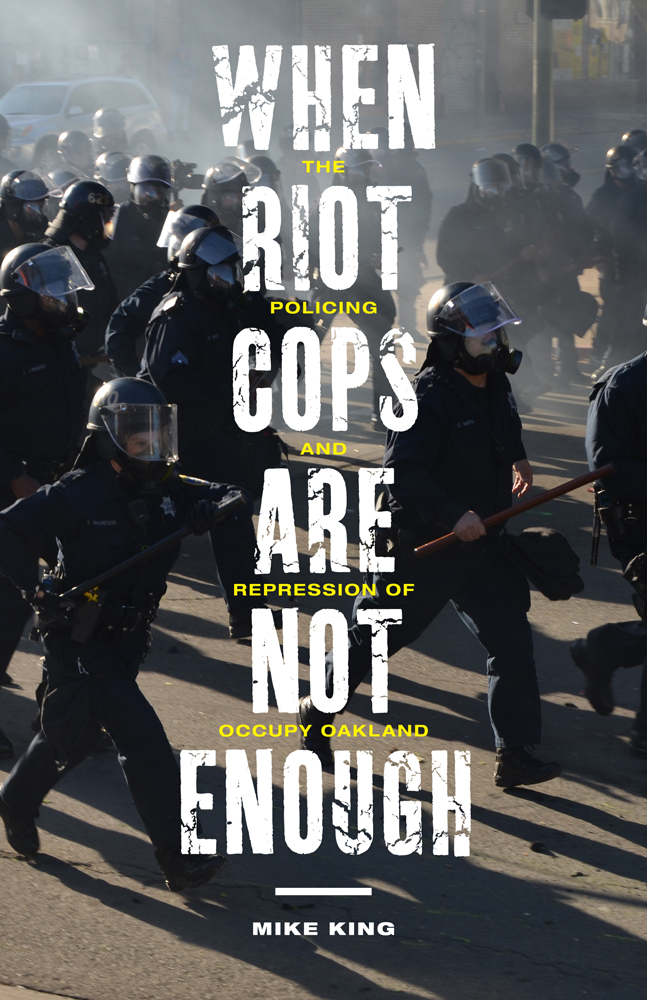
When Riot Cops Are Not Enough In When Riot Cops Are Not Enough, sociologist and activist Mike King examines the policing, and broader political repression, of the Occupy Oakland movement during the fall of 2011 through the spring of 2012. King’s active and daily participation in that movement, from its inception through its demise, provides a unique insider perspective to illustrate how the Oakland police and city administrators lost the ability to effectively control the movement. Drawn from King’s intensive field work, the book focuses on the physical, legal, political, and ideological dimensions of repression—in the streets, in courtrooms, in the media, in city hall, and within the movement itself—When Riot Cops Are Not Enough highlights the central role of political legitimacy, both for mass movements seeking to create social change, as well as for governmental forces seeking to control such movements. Although Occupy Oakland was different from other Occupy sites in many respects, King shows how the contradictions it illuminated within both social movement and police strategies provide deep insights into the nature of protest policing generally, and a clear map to understanding the full range of social control techniques used in North America in the twenty-first century. POLITICAL SCIENCE,General
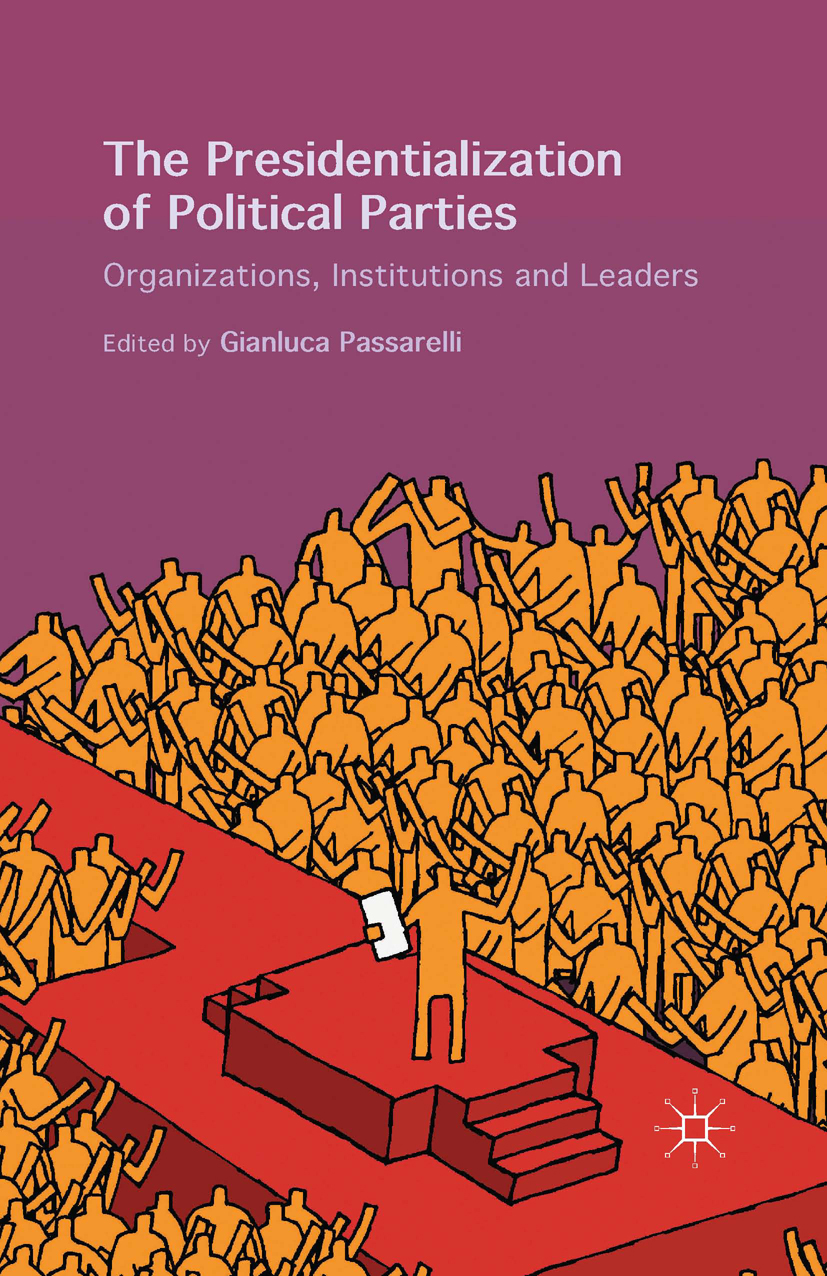
The Presidentialization of Political Parties This book explains why the level of party presidentialization varies from one country to another. It considers the effects of constitutional structures as well as the party's original features, and argues that the degree of party presidentialization varies as a function of the party's genetics. POLITICAL SCIENCE,General
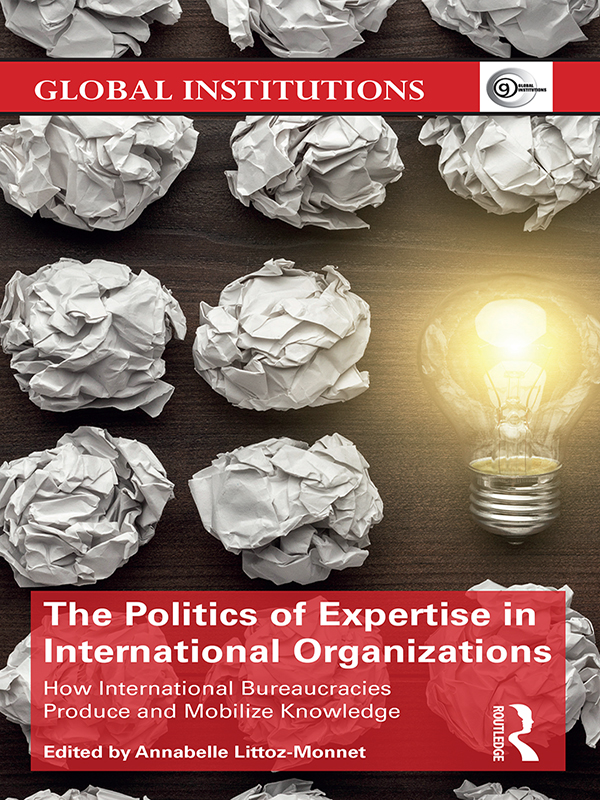
The Politics of Expertise in International Organizations This edited volume advances existing research on the production and use of expert knowledge by international bureaucracies. Given the complexity, technicality and apparent apolitical character of the issues dealt with in global governance arenas, ‘evidence-based’ policy-making has imposed itself as the best way to evaluate the risks and consequences of political action in global arenas. In the absence of alternative, democratic modes of legitimation, international organizations have adopted this approach to policy-making. By treating international bureaucracies as strategic actors, this volume address novel questions: why and how do international bureaucrats deploy knowledge in policy-making? Where does the knowledge they use come from, and how can we retrace pathways between the origins of certain ideas and their adoption by international administrations? What kind of evidence do international bureaucrats resort to, and with what implications? Which types of knowledge are seen as authoritative, and why? This volume makes a crucial contribution to our understanding of the way global policy agendas are shaped and propagated. It will be of great interest to scholars, policy-makers and practitioners in the fields of public policy, international relations, global governance and international organizations. POLITICAL SCIENCE,General
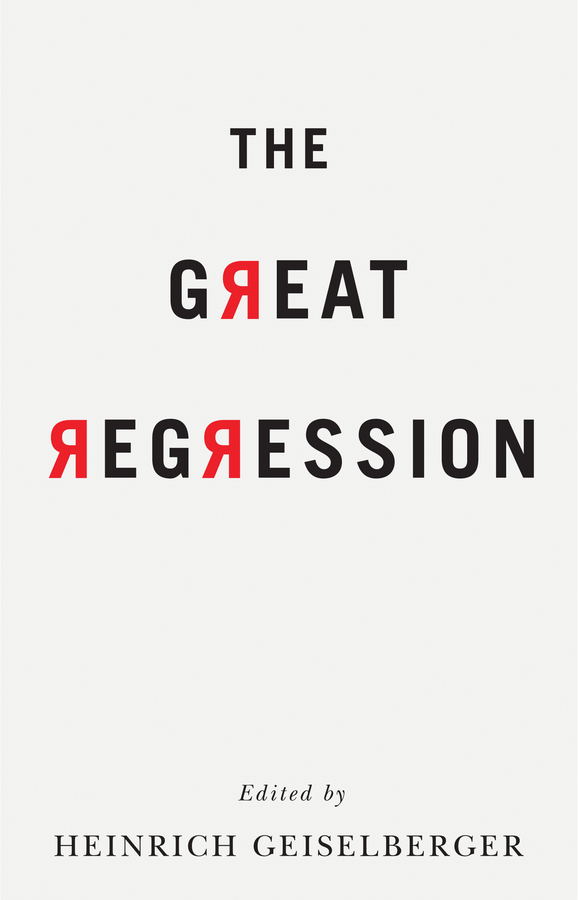
The Great Regression We are living through a period of dramatic political change – Brexit, the election of Trump, the rise of extreme right movements in Europe and elsewhere, the resurgence of nationalism and xenophobia and a concerted assault on the liberal values and ideals associated with cosmopolitanism and globalization. Suddenly we find ourselves in a world that few would have imagined possible just a few years ago, a world that seems to many to be a move backwards. How can we make sense of these dramatic developments and how should we respond to them? Are we witnessing a worldwide rejection of liberal democracy and its replacement by some kind of populist authoritarianism? This timely volume brings together some of the world's greatest minds to analyse and seek to understand the forces behind this 'great regression'. Writers from across disciplines and countries, including Paul Mason, Pankaj Mishra, Slavoj Zizek, Zygmunt Bauman, Arjun Appadurai, Wolfgang Streeck and Eva Illouz, grapple with our current predicament, framing it in a broader historical context, discussing possible future trajectories and considering ways that we might combat this reactionary turn. The Great Regression is a key intervention that will be of great value to all those concerned about recent developments and wondering how best to respond to this unprecedented challenge to the very core of liberal democracy and internationalism across the world today. For more information, see: www.thegreatregression.eu POLITICAL SCIENCE,General

Comparing Political Corruption and Clientelism Past modernization literature has assumed that corruption and clientelism reflect a pre-modern social structure and could be referred to as a pathologic phenomenon of the political system. Very few have considered corruption and clientelism as structural products of an interwoven connection between capital accumulation, bureaucratic rationalization, interest intermediation and political participation from below. This volume analyzes key aspects of the debate such as: should corruption and clientelism be evaluated as a 'lubricant' in terms of administrative efficiency - legitimate demands from the margins of society to redress social and economic inequality or to readdress economic development? What would be the effect of strengthening policing to control political corruption? Could electoral reform or a decentralization of government power be a cure for all? These questions among others are answered in this comprehensive volume. POLITICAL SCIENCE,General

Political Science Approaching the subject from a focussed international and pluralist perspective, this book provides advanced-level treatment of all the core areas to give postgraduate students a wide-ranging and dynamic introduction POLITICAL SCIENCE,General
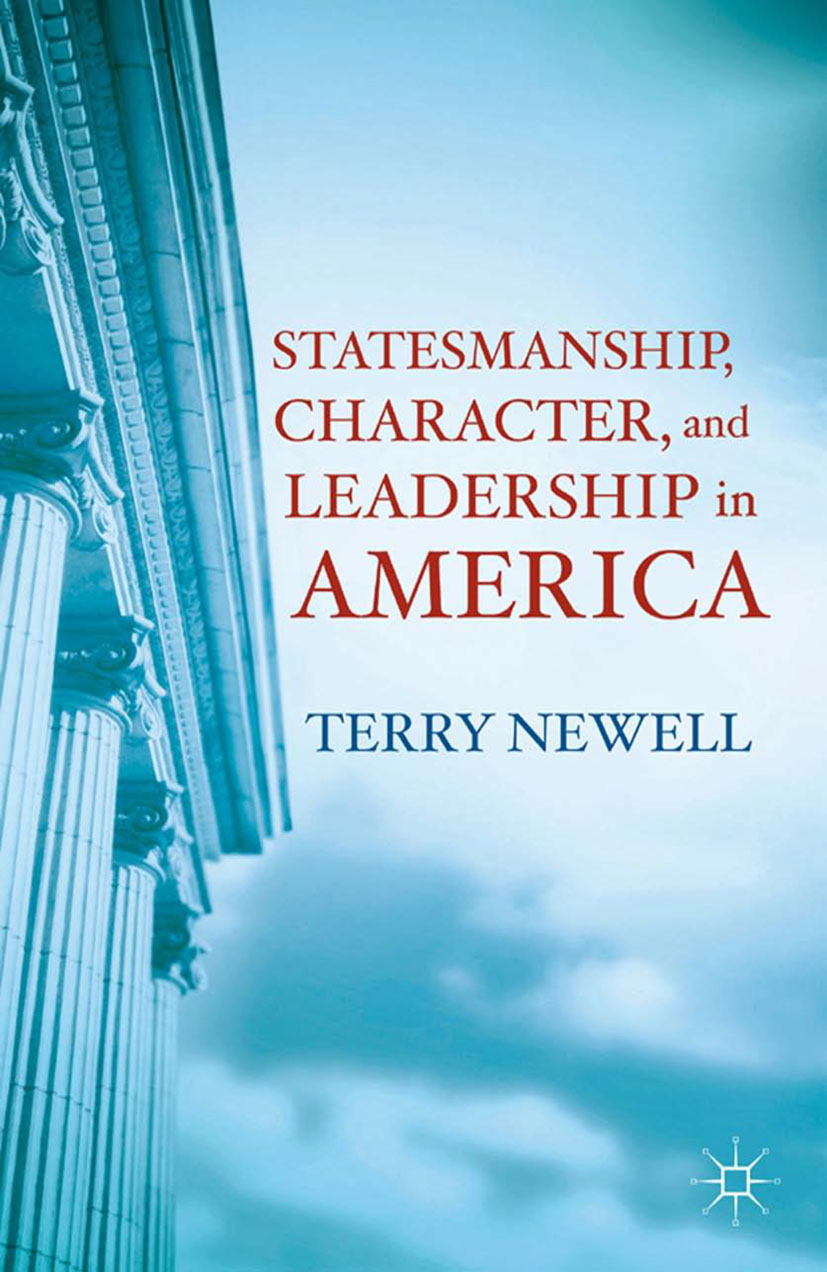
Statesmanship, Character, and Leadership in America Newell examines noted Americans at seven critical turning points in American history to look at what it takes to be a statesman.Through a powerful speech and the events preceding and following it, they show us how they grappled with conflicting values, varying demands, and the uncertainties of trying to forge a good society. POLITICAL SCIENCE,General
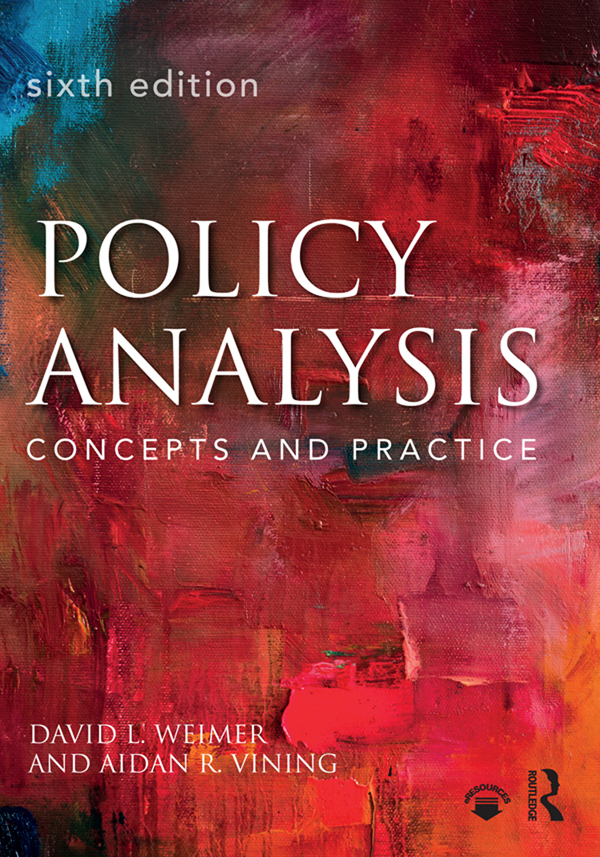
Policy Analysis Often described as a public policy “bible,†Weimer and Vining remains the essential primer it ever was. Now in its sixth edition, Policy Analysis provides a strong conceptual foundation of the rationales for and the limitations to public policy. It offers practical advice about how to do policy analysis, but goes a bit deeper to demonstrate the application of advanced analytical techniques through the use of case studies. Updates to this edition include: A chapter dedicated to distinguishing between policy analysis, policy research, stakeholder analysis, and research about the policy process. An extensively updated chapter on policy problems as market and governmental failure that explores the popularity of Uber and its consequences. The presentation of a property rights perspective in the chapter on government supply to help show the goal tensions that arise from mixed ownership. An entirely new chapter on performing analysis from the perspective of a public agency and a particular program within the agency’s portfolio: public agency strategic analysis (PASA). A substantially rewritten chapter on cost–benefit analysis, to better prepare students to become producers and consumers of the types of cost–benefit analyses they will encounter in regulatory analysis and social policy careers. A new introductory case with a debriefing that provides advice to help students immediately begin work on their own projects. Policy Analysis: Concepts and Practices remains a comprehensive, serious, and rich introduction to policy analysis for students in public policy, public administration, and business programs. POLITICAL SCIENCE,General

Critical Methods in Political and Cultural Economy Critical Methods in Political and Cultural Economy offers students and scholars the first methods book for the critical school of International Political Economy (IPE). What does it mean to ‘do’ critical research? How do we write about the evidence we present? This volume explores our shared critical ethic to demonstrate how methods are transformative and reimagines research strategies as both an embodied practice and a social process. By presenting methodologically informed ways of researching, enriched by real-life accounts from academics doing empirical research, the volume seeks to forge a new collaborative path that builds a critical ethic and modes of inquiry within International Political Economy. Substantive chapters advance the pluralism of the critical school of cultural political economy and seek to articulate its nascent research ethic. Short autobiographical vignettes articulate the professional journeys of contributors who ‘do’ critical political economy. There is practical advice on how to develop evidence from an iterative reflexive research strategy. Using this innovative format offers a guide to methods in critical political economy by engaging directly with the people doing research, not only as technical practice but also as lived experience. The combination of research and practice presented throughout the book offers an extensive and authoritative framework for evaluating how methods are part of critical research and will be essential reading for all students and scholars of IPE. POLITICAL SCIENCE,General

Quantitative Social Science The Stata edition of the groundbreaking textbook on data analysis and statistics for the social sciences and allied fields Quantitative analysis is an increasingly essential skill for social science research, yet students in the social sciences and related areas typically receive little training in it—or if they do, they usually end up in statistics classes that offer few insights into their field. This textbook is a practical introduction to data analysis and statistics written especially for undergraduates and beginning graduate students in the social sciences and allied fields, such as business, economics, education, political science, psychology, sociology, public policy, and data science. Quantitative Social Science engages directly with empirical analysis, showing students how to analyze data using the Stata statistical software and interpret the results—it emphasizes hands-on learning, not paper-and-pencil statistics. More than fifty data sets taken directly from leading quantitative social science research illustrate how data analysis can be used to answer important questions about society and human behavior. Proven in classrooms around the world, this one-of-a-kind textbook features numerous additional data analysis exercises, and also comes with supplementary teaching materials for instructors. Written especially for students in the social sciences and allied fields, including business, economics, education, psychology, political science, sociology, public policy, and data science Provides hands-on instruction using Stata, not paper-and-pencil statistics Includes more than fifty data sets from actual research for students to test their skills on Covers data analysis concepts such as causality, measurement, and prediction, as well as probability and statistical tools Features a wealth of supplementary exercises, including additional data analysis exercises and interactive programming exercises Offers a solid foundation for further study Comes with additional course materials online, including notes, sample code, exercises and problem sets with solutions, and lecture slides POLITICAL SCIENCE,General
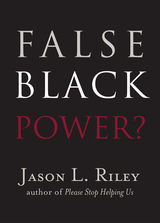
False Black Power? Black civil rights leaders have long supported ethnic identity politics and prioritized the integration of political institutions, and seldom has that strategy been questioned. In False Black Power?, Jason L. Riley takes an honest, factual look at why increased black political power has not paid off in the ways that civil rights leadership has promised. Recent decades have witnessed a proliferation of black elected officials, culminating in the historic presidency of Barack Obama. However, racial gaps in employment, income, homeownership, academic achievement, and other measures not only continue but in some cases have even widened. While other racial and ethnic groups in America have made economic advancement a priority, the focus on political capiÂtal for blacks has been a disadvantage, blocking them from the fiscal capital that helped power upward mobility among other groups. Riley explains why the political strategy of civil rights leadÂers has left so many blacks behind. The key to black ecoÂnomic advancement today is overcoming cultural handicaps, not attaining more political power. The book closes with thoughtful responses from key thought leaders Glenn Loury and John McWhorter. POLITICAL SCIENCE,General
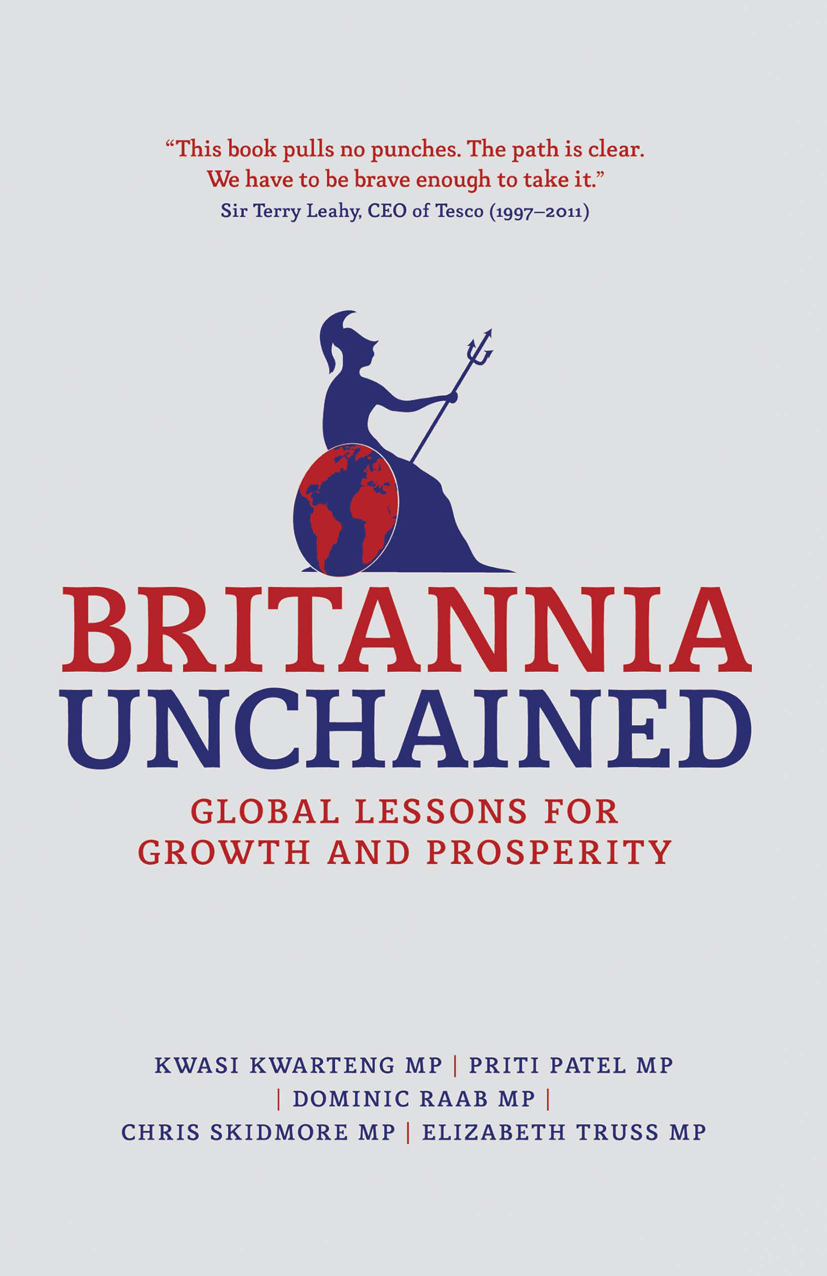
Britannia Unchained Britain is at a cross-roads; from the economy, to the education system, to social mobility, Britain must learn the rules of the 21st century, or face a slide into mediocrity. Brittania Unchained travels around the world, exploring the nations that are triumphing in this new age, seeking lessons Britain must implement to carve out a bright future. POLITICAL SCIENCE,General
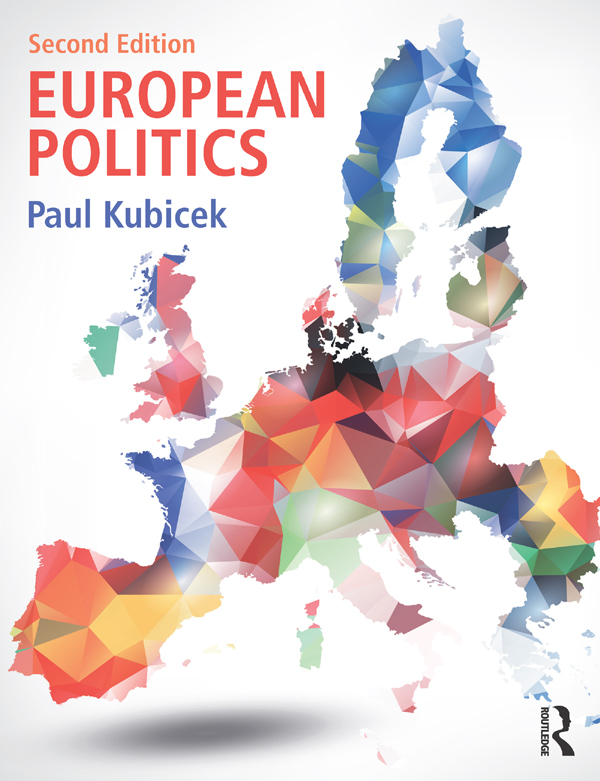
European Politics European Politics surveys the history, institutions, and issues that are essential for understanding contemporary European politics. Exploring a central question—"what is Europe?"—this text's thematic approach helps students compare politics in individual countries and see the political big picture in the region. European Politics examines not only countries already in the European Union but also those eligible to join to give students the most comprehensive picture of Europe's evolution in a globalized world. Key changes for the new edition: Fully revised and updated to include coverage of recent elections, public opinion data and key topics such as refugees, Russia and Ukraine, Syria, more on the economic crisis, and Brexit; Expanded and revised opening chapter explaining Europeanization, multi-level governance, and the fissures in Europe; Greater and updated coverage of theory, multi-culturalism, and the EU. This timely, in-depth text will be essential reading for anyone interested in European politics. POLITICAL SCIENCE,General

Advanced Aluminum Alloys Containing Scandium This is the first book to generalize and analyze the extensive experimental and theoretical results on the phase composition, structure, and properties of aluminum alloys containing scandium. The effects of scandium on these properties are studied from a physico- chemical viewpoint. The authors present binary, ternary, and more complex phase diagrams for these alloys and consider in detail recrystallization, superplastic behavior, and decomposition of supersaturated solid solutions and the effects of solidification conditions on phase equilibria. POLITICAL SCIENCE,General
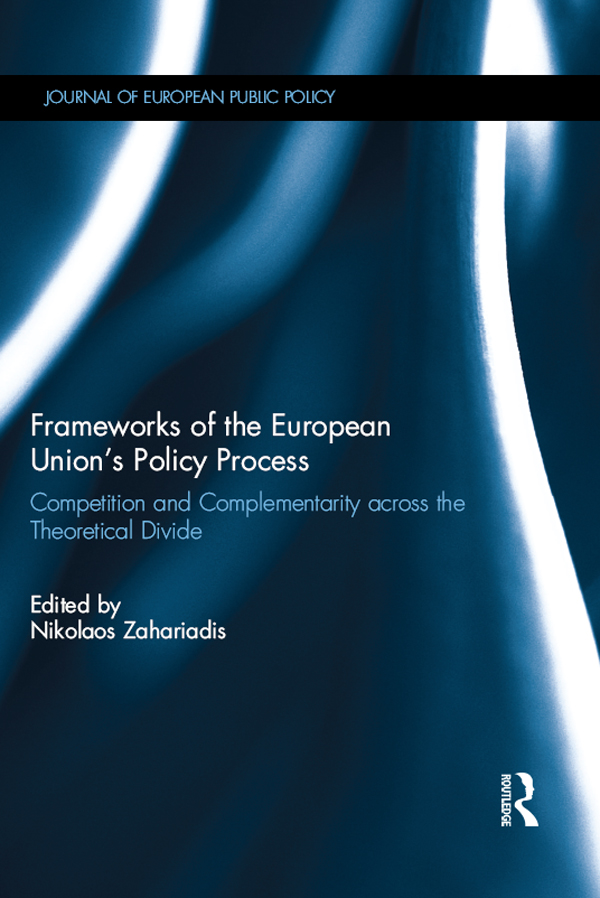
Frameworks of the European Union's Policy Process The book advances the state of the European Union‘s policy theory by taking stock of seven promising frameworks of the policy process, systematically comparing their limitations and strengths, and offering a strategy to develop robust research agendas. Frameworks may constitute competing policy explanations depending on assumptions they make about EU institutional and issue complexity. The frameworks include detailed analyses of multi-level governance, advocacy coalitions, punctuated equilibrium, multiple streams, policy learning, normative power Europe, and constructivism. Besides generating a fertile dialogue that transcends the narrow confines of EU policy, contributions highlight the value of intellectual pluralism and the need for clear and rigorous explanations of the policy process. This book was published as a special issue of the Journal of European Public Policy. POLITICAL SCIENCE,General
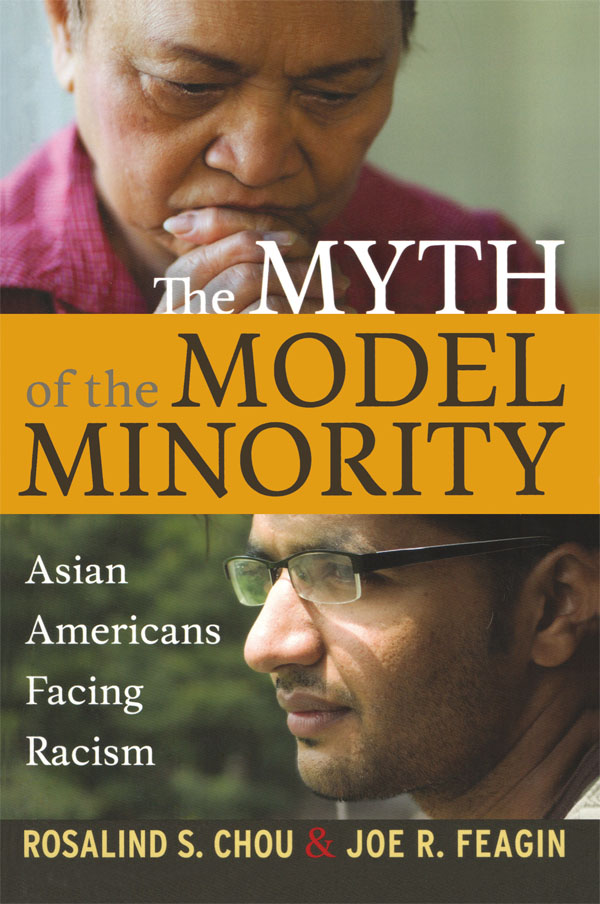
Myth of the Model Minority With their apparent success in schools and careers, Asian Americans have long been viewed by white Americans as the "model minority." Yet few Americans realize the lives of many Asian Americans are constantly stressed by racism. This reality becomes clear from the voices of Asian Americans heard in this first in-depth book on the experiences of racism among Asian Americans from many different nations and social classes. Chou and Feagin assess racial stereotyping and discrimination from dozens of interviews across the country with Asian Americans in a variety of settings, from elementary schools to colleges, workplaces, and other public arenas. They explore the widely varied ways of daily coping that Asian Americans employ-some choosing to conform and others actively resisting. This book dispels notions that Asian Americans are universally "favored" by whites and have an easy time adapting to life in American society. The authors conclude with policy measures that can improve the lives not only of Asian Americans but also of other Americans of color. POLITICAL SCIENCE,General
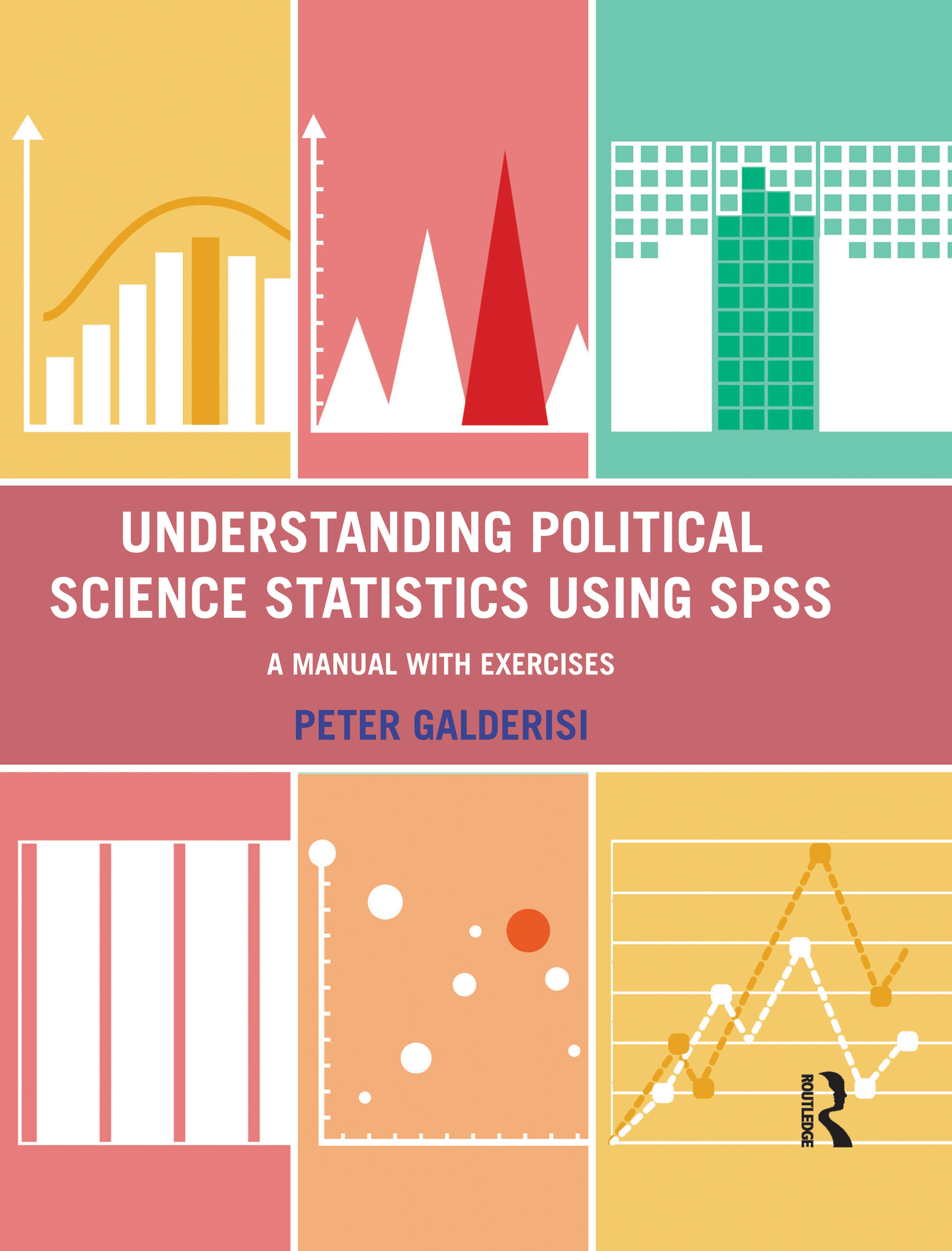
Understanding Political Science Statistics using SPSS This manual walks students through the procedures for analysis in SPSS and provides exercises that go hand-in-hand with online data sets. The manual complements the textbook Understanding Political Science Statistics: Observations and Expectations in Political Analysis, by Peter Galderisi, making it easy to use alongside the book in a course or as a stand-alone guide to using SPSS. Galderisi demonstrates how to use both syntax and GUI driven formats and shows sample results of the analyses. Filled with annotated screenshots from SPSS version 22 (but compatible with all versions, including the student version), the students will be guided through standard processes replete with examples and exercises to ready them for future work in political science research. The diverse group of data sets provided include subsamples of both the 2008 and 2012 American National Election Studies, a Eurobarometer survey, single year and longitudinal congressional district files, the 2012 Comparative Congressional Election Study data set, and a comparative, crossnational country file. Versions with reduced case numbers and variables are also included that are compatible with the student version.This manual (and a parallel Stata manual) are available as stand-alone products or packaged with the textbook Understanding Political Science Statistics. POLITICAL SCIENCE,General
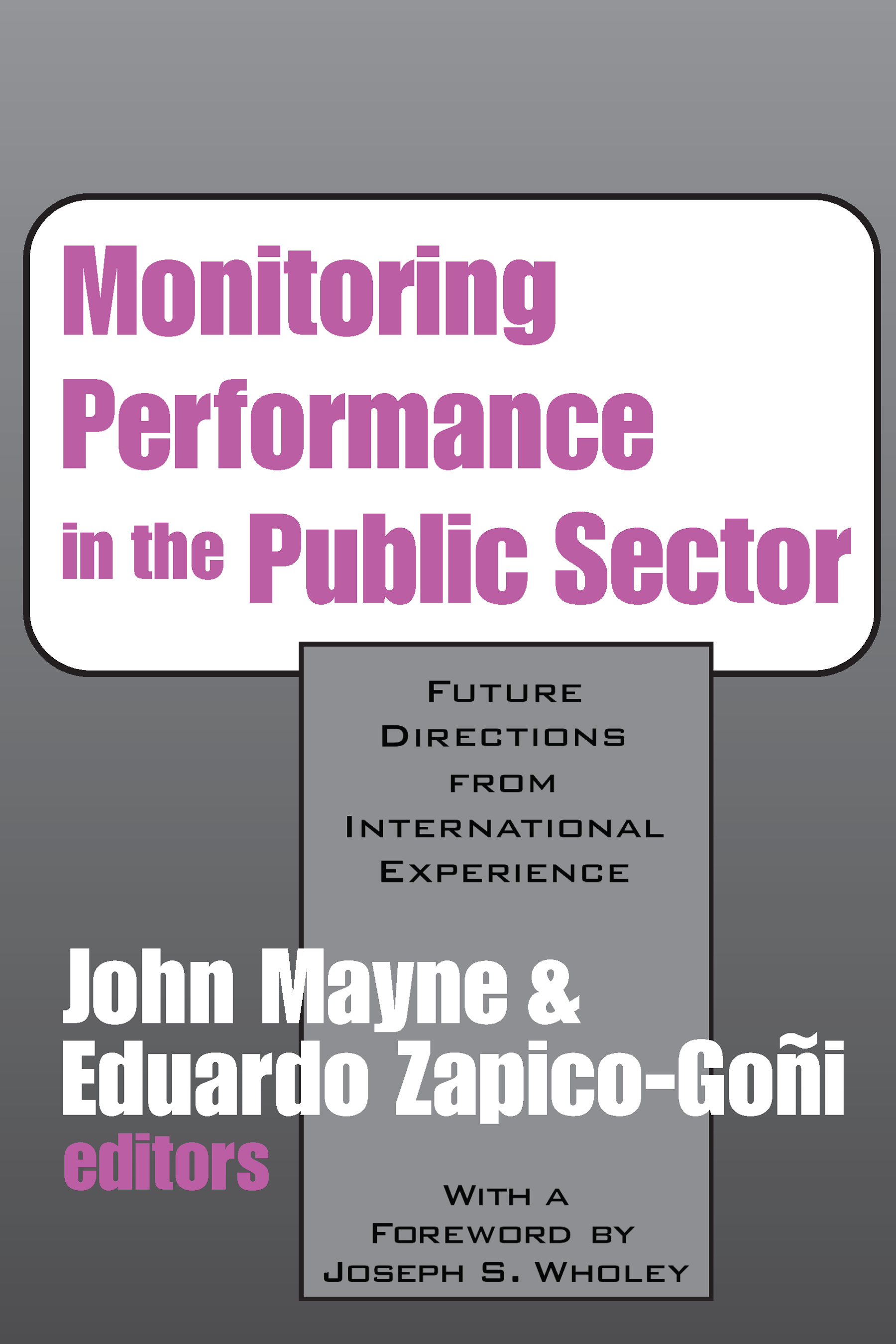
Monitoring Performance in the Public Sector A host of promising public sector reform efforts are underway throughout the world. In governments challenged by budget deficits and declining public trust, these reform efforts seek to improve policy decisions and public management. Along the way, program efficiency and effectiveness help rebuild public confidence in government. Whether through regular measurement of program inputs, activities, and outcomes, or through episodic one-shot studies, performance monitoring plays a central role in the most important current reform efforts. Monitoring Performance in the Public Sector, now available in paperback, is based on experiences derived from comparative analysis in different countries. It explains why there is interest in perfor!mance monitoring in a given setting, why it has failed or created uncertainties, and identifies criteria for improving its design and use.One of the challenges this book offers is the need to consider dimensions of performance beyond the traditional ones of economy, efficiency, and effectiveness. With an increasingly diverse, interdependent, and uncertain public sector environment, for some stakeholders meeting objectives fixed some time ago may not be as important as the capacity to adapt to current and future change. In this vein, the contributors address a number of themes: the criti!cal importance of organizational support for performance monitoring and making it consistent with the organizational culture, the need for active and effective leadership in defining criteria and implementing practical performance monitoring, the value of linking ongoing measurement with more than the traditional, strictly quantitative aspects of public sector performance.As we gain experience with performance monitoring and its uses, such systems should become more cost effective over time. This book will be of deep interest to public managers, government officials, economists, and organization theorists, and useful in courses on p POLITICAL SCIENCE,General

Fascism For Italian intellectuals, the terms fascist and antifascist continue to be the hard currency of contemporary political debate-to the point that if you are not one, you must be the other. When professor Renzo de Felice suggests that fascism describes a moment in the Italian past-and only that-he is challenging the very heart of current orthodoxy. The nature of his analysis of the recent Italian past is itself at odds with the traditional version, and represents a radical departure from conventional wisdom. De Felice's ideas about fascism have a broad signifi cance, quite apart from their importance in the contemporary Italian scene. Perhaps no one knows as much about fascism, and no one has given the subject such a rigorous historical analysis. POLITICAL SCIENCE,General
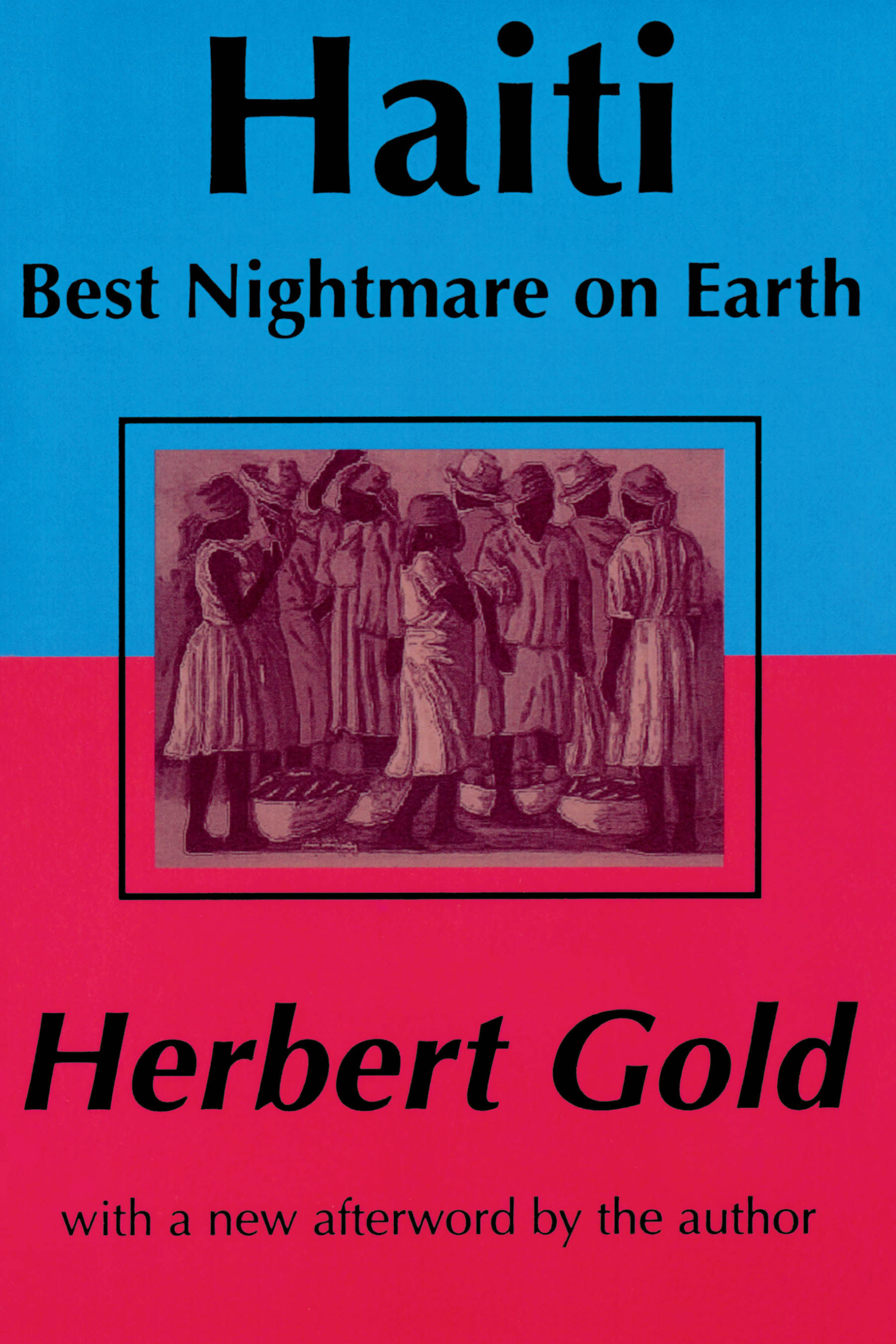
Haiti Five decades ago, award-winning author Herbert Gold traveled to Haiti on a Caribbean version of the Fulbright Scholarship. The journey proved to be a turning point in his life. Fifty years later, his attachment to the tiny Caribbean nation-his second home-remains as passionate and powerful as ever. Now, in Best Nightmare on Earth, he explores the secret life of this vibrant, volatile, violent land. -Beautiful...bizarre...dangerous...exotic, a Garden of Eden fallen into despair, a tiny nation of unimaginable misery and unpredictable grace, an island where life is a kind of literature, a world of -unlimited impossibility.- This is Herbert Gold's Haiti, a country of extraordinary paradox and remarkable extremes-of gingerbread dream houses and wretched slums, of brutal repression and explosive creative energy. Where else, he asks, can you run into evil spirits on the back roads, or find the goddess of fertility and orgasm represented by a photo of a tap-dancing Shirley Temple? Where else is there such generosity amid such corruption, such humor in the midst of such desperation? In his many Haitian travels, Gold has dined with Graham Greene and chatted with the hated Duvalier oppressors. He has traded stories with CIA saboteurs, former Nazis, rum-soaked diplomats, and voodoo priests. He has taken in the cockfights and hunted for pirate treasure. He has nearly died of malaria; he has faced machete-wielding gangs of Ton-Ton Macoutes. He followed the traffic in Haitian blood to American hospitals and watched the AIDS epidemic take its toll. He listened to the steady beat of drums rolling down mist-shrouded mountains, and shared in the flirting, drinking, and laughter of the streets. He has captured the essence of this land where tragedy is the music the people dance to. Herbert Gold reflects on the country's history and politics, culture and folklore, but sees much more. He sees Haiti through the eyes of a lover: impassioned, jealous, probing, ever alert, and alive. This book will be of interest to travelers to, and people interested in the problems of, Haiti and the Caribbean; and collectors of Haitian art. POLITICAL SCIENCE,General

The Opium of the Intellectuals Raymond Aron's 1955 masterpiece The Opium of the Intellectuals, is one of the great works of twentieth- century political reflection. Aron shows how noble ideas can slide into the tyranny of "secular religion" and emphasizes how political thought has the profound responsibility of telling the truth about social and political reality-in all its mundane imperfections and tragic complexities.Aron explodes the three "myths" of radical thought: the Left, the Revolution, and the Proletariat. Each of these ideas, Aron shows, are ideological, mystifying rather than illuminating. He also provides a fascinating sociology of intellectual life and a powerful critique of historical determinism in the classically restrained prose for which he is justly famous.For this new edition, prepared by Daniel J. Mahoney and Brian C. Anderson as part of Transaction's ongoing "Aron Project," political scientist Harvey Mansfield provides a luminous introduction that underscores the permanent relevance of Aron's work. The new edition also includes as an appendix "Fanaticism, Prudence, and Faith," a remarkable essay that Aron wrote to defend Opium from its critics and to explain further his view of the proper role of political thinking. The book will be of interest to all students of political theory, history, and sociology. POLITICAL SCIENCE,General
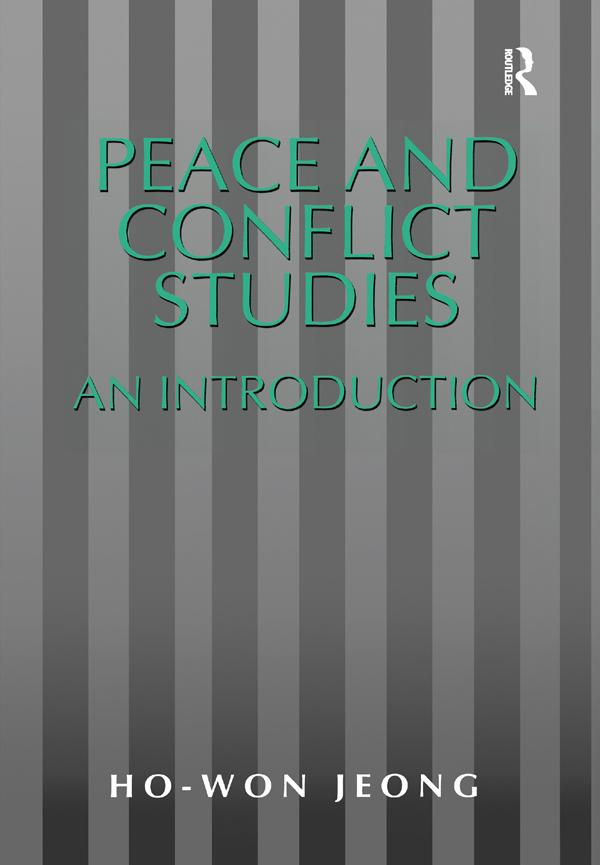
Peace and Conflict Studies Ho-Won Jeong explains and assesses major approaches to dealing with ethnic conflict, communal violence, inter-state war and social injustice. The book analyses not only the sources of violence and conflict, but also how to manage and prevent them. As peace is relevant to improvement in human well-being and the future survival of humanity, the volume encompasses a variety of themes, ranging from alternative security policies, methods of peaceful settlement, human rights, self-determination, environmental politics, global governance and non-violence. Reflecting on the current thinking and drawing lessons from the past, the book can be considered as the most authoritative introduction to the field since the end of the Cold War. POLITICAL SCIENCE,General

Global Power Transition and the Future of the European Union Today, the European Union faces challenges that threaten not only internal cohesion but also its position in the global system. This book is about the future of the EU in the light of global power transition taking place in the twenty-first century and demonstrates how its future rests on a delicate balance between policy challenge, member states’ interests, and convergence or divergence of societal values across its peoples. The book examines factors behind the decline of the EU relative to the rise of China and other powers in the global hierarchy and what policy options are available for EU leaders to implement in order to compete as a global actor. It analyses determinants of regional integration and key policy challenges the EU faces in its quest for an "ever deeper union," and identifies significant factors (i.e., power relations, economic relations, emergent social values across the EU) that can explain the likelihood of further integration or conflict between EU member states. This text will be essential reading for scholars, students, and practitioners interested in European Union politics international relations, security studies, and comparative politics. POLITICAL SCIENCE,General

Environmental Policy and Politics Covering global threats such as climate change, population growth, and loss of biodiversity, as well as national, state, and local problems of environmental pollution, energy use, and natural resource use and conservation, Environmental Policy and Politics provides a comprehensive overview of U.S. policymaking processes, the legislative and administrative settings for policy decisions, the role of interest groups and public opinion in environmental politics, and the public policies that result. It helps readers understand modern environmental policy and its implications, including the need for a comprehensive and integrated approach to problem-solving. New to the Seventh Edition Each chapter includes the latest information about environmental challenges and governmental responses to them, with extensive citation of sources and websites that allow students to find the most recent studies and reports. Each chapter covers key political and policy decisions through early 2017, including presidential appointments, budgetary decisions, major legislative initiatives, and congressional actions. Each chapter introduction includes new statements about learning objectives to facilitate student understanding of key concepts and their applications, arguments advanced over environmental challenges and policies, and the goals and methods of environmental policy analysis. Chapters compare decisions about major environmental, energy, and natural resource policies among the presidential administrations of George W. Bush, Barack Obama, and Donald Trump, to the extent possible. Each chapter’s case studies have been changed or updated to include the latest developments and examples that should improve their appeal to students. These include controversies over the Keystone XL and Dakota Access pipelines, the EPA’s Clean Power Plan and new fuel economy standards, new policies on toxic chemicals, the role of environmental and energy policies in the 2016 elections, changes in the nation’s reliance on energy resources, standards for evaluating environmental and resource policies, and the Paris Agreement on climate change. Summaries of scientific studies, government reports, and policy analyses have been updated throughout the text to reflect the most current research and information in the field. All chapters include revised discussion questions and new suggested readings. The writing and flow of material have been improved throughout to make the chapters more accessible and useful to students. POLITICAL SCIENCE,General

Routledge Handbook of Religion and Politics From the United States to the Middle East, Asia and Africa, religion continues to be an important factor in political activity and organisation. The second edition of this successful handbook provides the definitive global survey of the interaction of religion and politics. Featuring contributions from an international team of experts, it examines the political aspects of all the world's major religions, including such crucial contemporary issues as religious fundamentalism, terrorism, the 'war on terror', the 'clash of civilizations', the Arab Spring, and science and religion. Each chapter has been updated to reflect the latest developments and thinking in the field, and new chapters such as ‘Postsecularism and international relations’ and ‘Securitization and Secularization: The two pillars of state regulation of European Islam’ have been added to ensure the book is a comprehensive and up-to-date resource. Four main themes addressed include: World religions and politics Religion and governance Religion and international relations Religion, security and development References at the end of each chapter have been overhauled to guide the reader towards the most up-to-date information on various topics. This book is an indispensable source of information for students, academics and the wider public interested in the dynamic relationship between politics and religion. POLITICAL SCIENCE,General

Speaking With a Single Voice Under what conditions does the internal cohesiveness of the European Union determine its external effectiveness on the world stage? This book asks this question, investigating the frequent political assumption that the more cohesive the EU presents itself to the world, the more effective it is in achieving its goals. Contributions to this book explore this theory from a range of perspectives, from trade to foreign policy, and highlight complex patterns between internal cohesiveness and external effectiveness. These are simplified into three possible configurations: internal cohesiveness has a positive impact on external effectiveness; internal cohesiveness has no impact on external effectiveness; and internal cohesiveness has a negative impact on external effectiveness. The international context in which the EU operates, which includes the bargaining configuration and the policy arena, functions as an intervening variable that helps us to explain variation in these causal links. The book also launches a research agenda aimed at explaining these patterns more systematically and determining the marginal impact of cohesiveness on effectiveness. This book was originally published as a special issue of the Journal of European Public Policy. POLITICAL SCIENCE,General
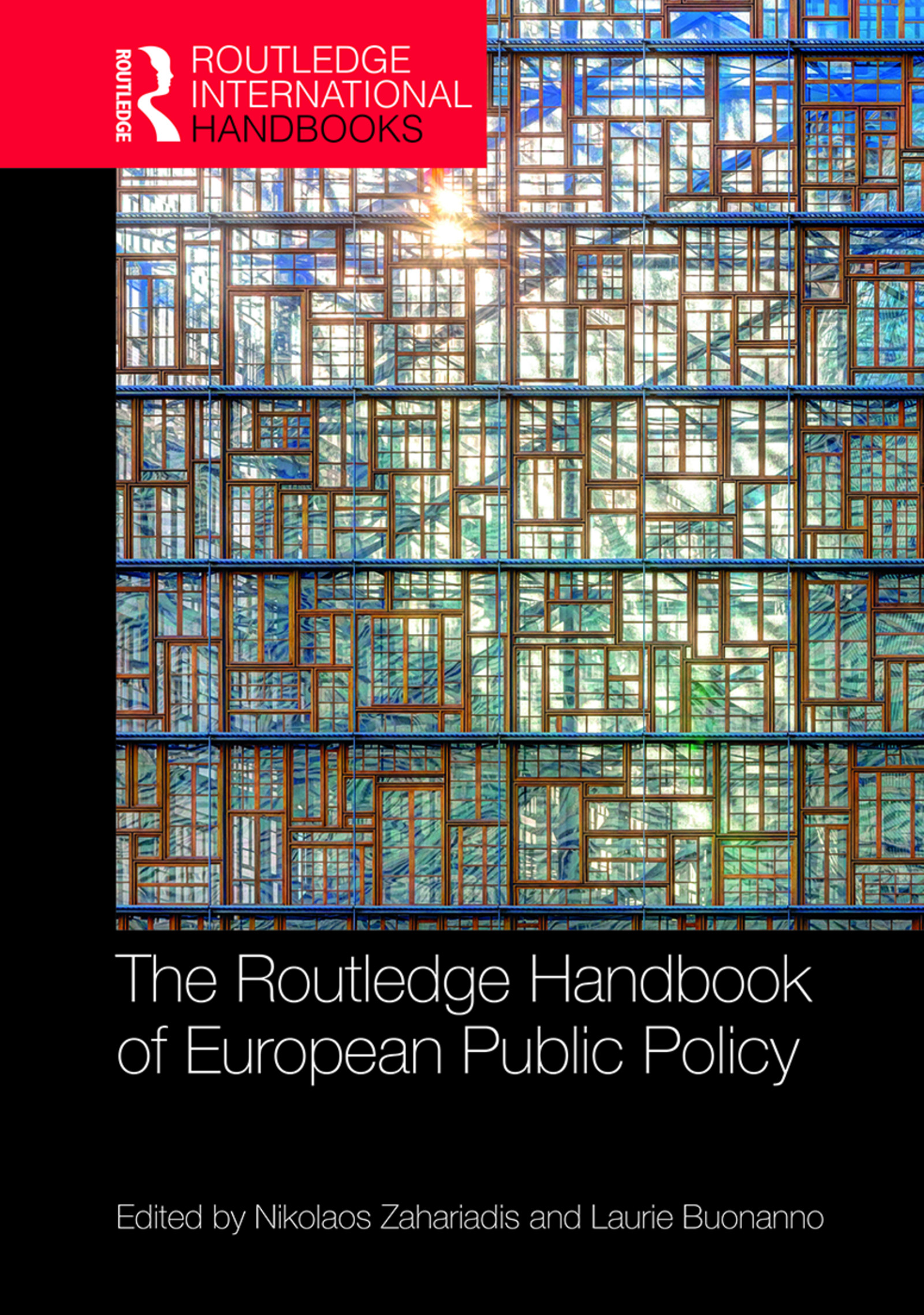
The Routledge Handbook of European Public Policy The Routledge Handbook of European Public Policy provides an in-depth and systematic understanding of EU policies. It covers theoretical approaches on the policy process and the various stages of public policy formulation and decision making, and discusses key questions of contemporary European governance. The handbook introduces major concepts, trends, and methodologies in a variety of comparative settings thereby providing the first systematic effort to include theoretical and substantive analyses of European public policies in a single volume. The handbook is divided into four sections: Concepts and approaches in EU policymaking; Substantive policies of the EU, including economic and social, fiscal and monetary, areas of freedom, security, and justice, and external policies; Elements of the policy cycle; Themes ranging from crisis and resistance to controversies in education. This handbook will be an essential reference for students and scholars of the European Union, public policy, social policy, and more broadly for European and comparative politics. POLITICAL SCIENCE,General
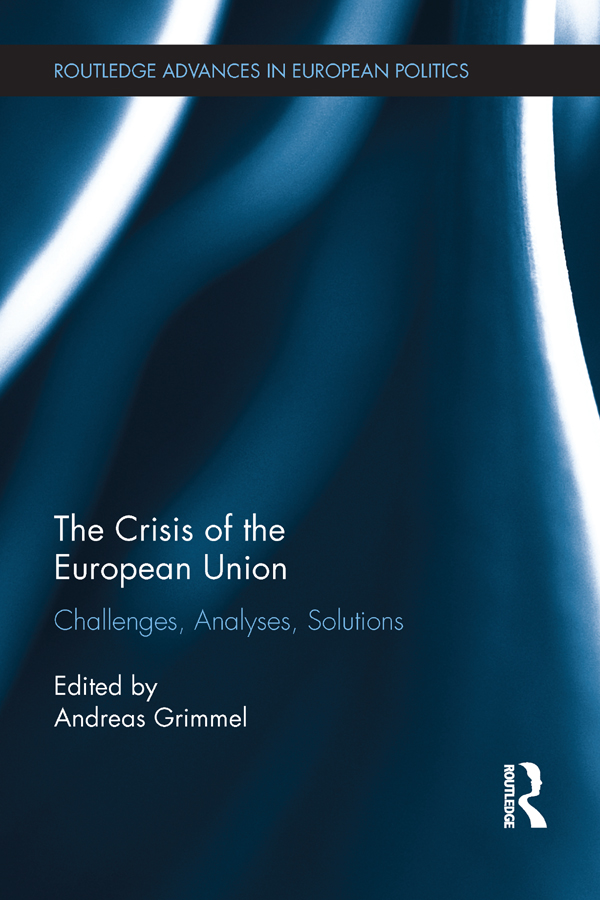
The Crisis of the European Union The European integration project currently faces profound political, economic, legal, and societal challenges. These challenges seem increasingly to overburden the European Union as well as the cohesion among the Member States, and therefore pose a serious threat to the integration project. The EU faces a major task in coping with this situation and it is one that calls for new approaches and ideas This book addresses the major challenges confronting the EU, analyses the consequences for the integration project, and develops fresh perspectives on the EU’s future prospects for coping with the most debated, current and upcoming issues, such as the rise of Euroscepticism or the contested idea of an ‘ever-closer union’. Renowned experts in European Studies from the fields of political science, law, economics and sociology provide an interdisciplinary perspective on the different dimensions of the EU’s crisis-laden situation and question whether the EU’s existing problem-solving mechanisms and methods are sufficient to address the imminent tasks. This text will be of key interest to scholars and students of EU Politics, European Politics, European Governance, and more broadly European law, history and the wider social sciences. POLITICAL SCIENCE,General
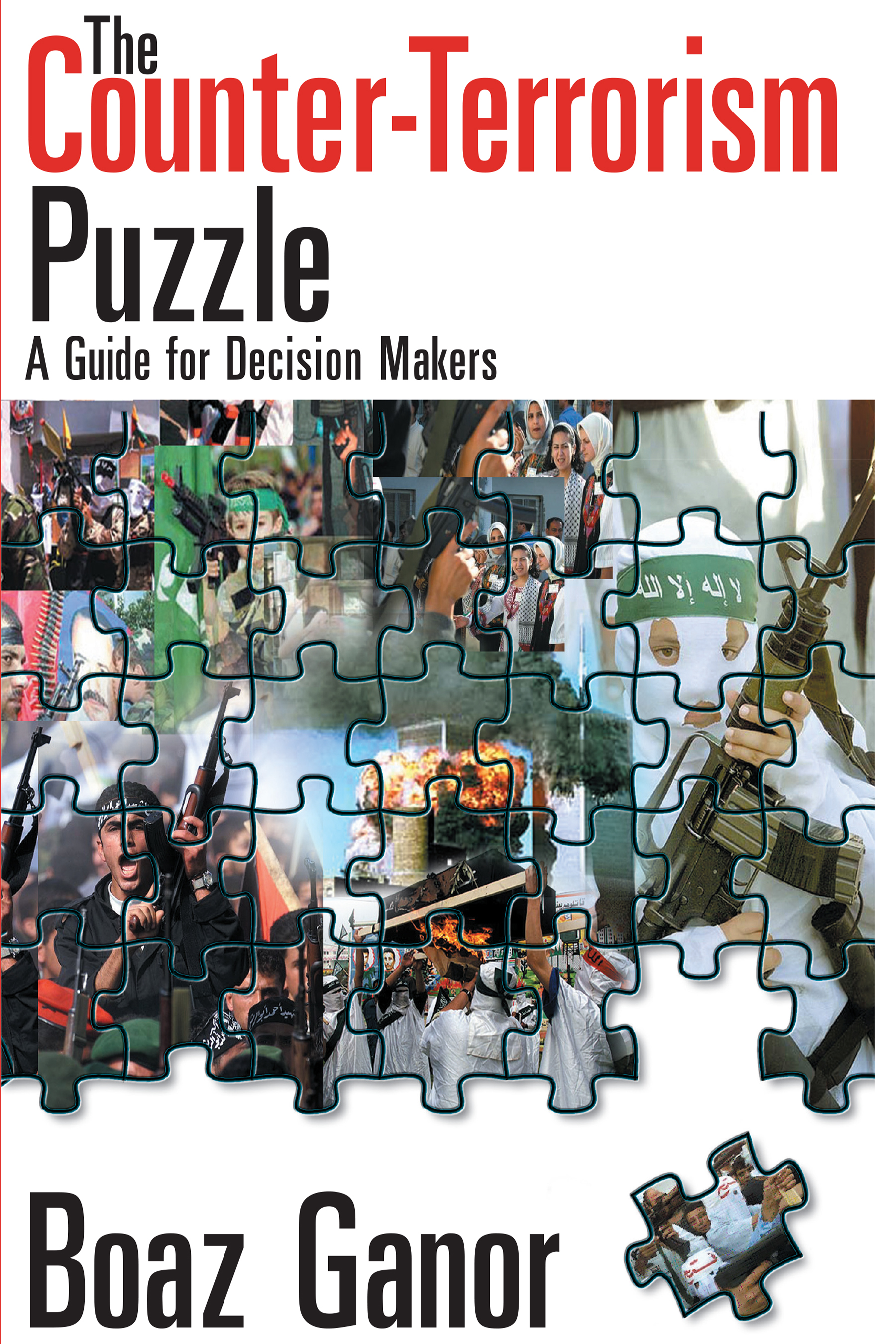
The Counter-terrorism Puzzle The expansion and escalation of global terrorism has left populations across the world and decision-makers responsible for contending with it unprepared. This book, now in paperback, is the first attempt of its kind to create a manual of counter-terrorism measures on all the relevant operational levels. The author's main purpose is to give decision-makers the tools to make rational and effective decisions in both preventing and countering terrorism. The need to contend with terrorism can be found in almost every sphere of life: security, prevention and suppression of terrorism, legal and ethical dilemmas regarding democratic issues, such as the individual's human rights, intelligence interrogations, the right of the public to know, as well as coping with social, psychological, and media-related issues. POLITICAL SCIENCE,General
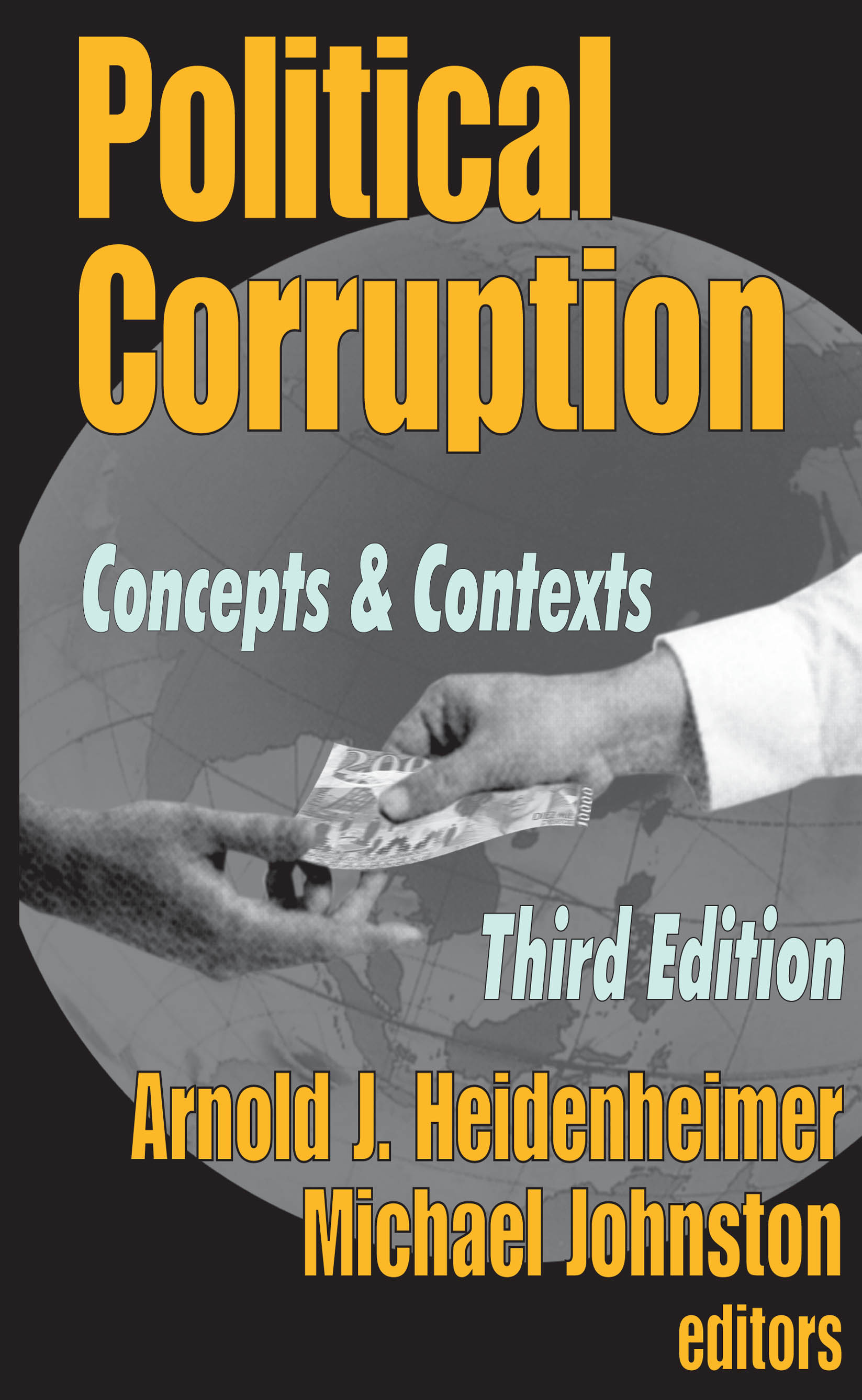
Political Corruption Corruption is once again high on the international policy agenda as a result of globalization, the spread of democracy, and major scandals and reform initiatives. But the concept itself has been a focus for social scientists for many years, and new findings and data take on richer meanings when viewed in the context of long-term developments and enduring conceptual debates. This compendium, a much-enriched version of a work that has been a standard reference in the field since 1970, offers concepts, cases, and fresh evidence for comparative analysis. Building on a nucleus of classic studies laying out the nature and development of the concept of corruption, the book also incorporates recent work on economic, cultural, and linguistic dimensions of the problem, as well as critical analyses of several approaches to reform. While many authors are political scientists, work by historians, economists, and sociologists are strongly represented. Two-thirds of the nearly fifty articles are based either on studies especially written or translated for this volume, or on selected journal literature published in the 1990s. The tendency to treat corruption as merely a synonym for bribery is illuminated by analyses of the diverse terminology and linguistic techniques that help distinguish corruption problems in the major languages. Recent attempts to measure corruption, and to analyze its causes and effects quantitatively are also critically examined. New contributions emphasize especially: corruption phenomena in Asia and Africa; contrasts among region and regime types; comparing U.S. state corruption incidence; European Party finance and corruption; assessments of international corruption rating project; analyses of international corruption control treaties; unintended consequences of anti-corruption efforts. Cumulatively, the book combines description richness, analytical thrust, conceptual awareness, and contextual articulation. POLITICAL SCIENCE,General
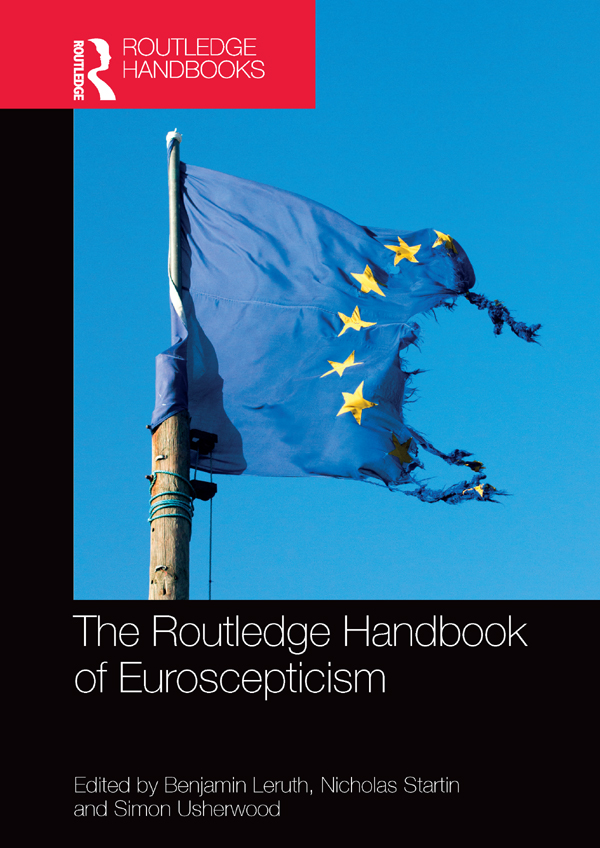
The Routledge Handbook of Euroscepticism Since the advent of the 1992 Maastricht Treaty, a key turning point in terms of the crystallisation of opposition towards the European Union (EU), Euroscepticism has become a transnational phenomenon. The term ‘Euroscepticism’ has become common political language in all EU member states and, with the advent of the Eurozone, refugee and security crises have become increasingly ‘embedded’ within European nation states. Bringing together a collection of essays by established and up-and-coming authors in the field, this handbook paints a fuller, more holistic picture of the extent to which the Eurosceptic debate has influenced the EU and its member states. Crucially, it also focuses on what the consequences of this development are likely to be for the future direction of the European project. By adopting a broad-based, thematic approach, the volume centres on theory and conceptualisation, political parties, public opinion, non-party groups, the role of referendums – and the media – and of scepticism within the EU institutions. It also reflects on the future of Euroscepticism studies following the United Kingdom’s vote to leave the EU. Containing a full range of thematic contributions from eminent scholars in the field, The Routledge Handbook of Euroscepticism is a definitive frame of reference for academics, practitioners and those with an interest in the debate about the EU, and more broadly for students of European Studies, EU and European Politics. POLITICAL SCIENCE,General
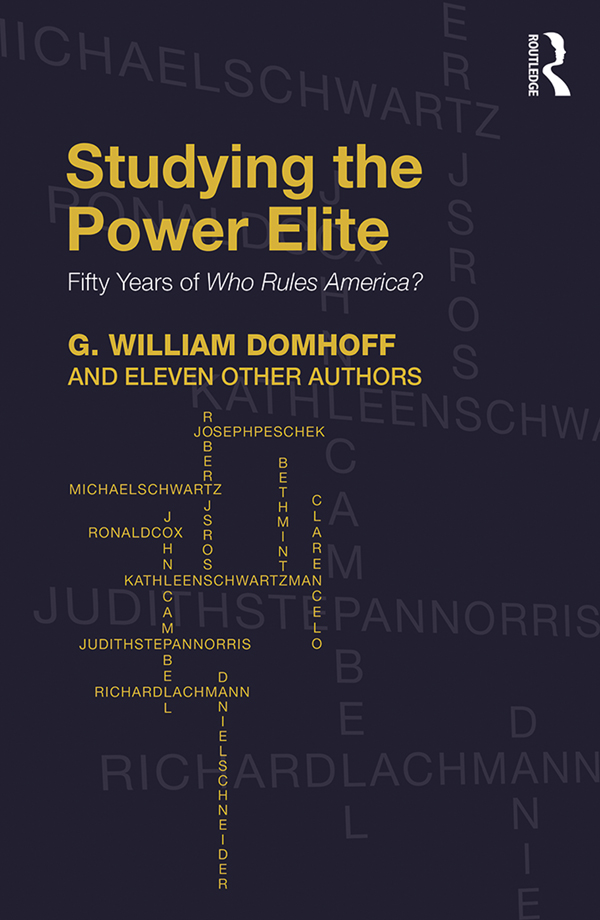
Studying the Power Elite This book critiques and extends the analysis of power in the classic, Who Rules America?, on the fiftieth anniversary of its original publication in 1967—and through its subsequent editions. The chapters, written especially for this book by twelve sociologists and political scientists, provide fresh insights and new findings on many contemporary topics, among them the concerted attempt to privatize public schools; foreign policy and the growing role of the military-industrial component of the power elite; the successes and failures of union challenges to the power elite; the ongoing and increasingly global battles of a major sector of agribusiness; and the surprising details of how those who hold to the egalitarian values of social democracy were able to tip the scales in a bitter conflict within the power elite itself on a crucial banking reform in the aftermath of the Great Recession. These social scientists thereby point the way forward in the study of power, not just in the United States, but globally. A brief introductory chapter situates Who Rules America? within the context of the most visible theories of power over the past fifty years—pluralism, Marxism, Millsian elite theory, and historical institutionalism. Then, a chapter by G. William Domhoff, the author of Who Rules America?, takes us behind the scenes on how the original version was researched and written, tracing the evolution of the book in terms of new concepts and research discoveries by Domhoff himself, as well as many other power structure researchers, through the 2014 seventh edition. Readers will find differences of opinion and analysis from chapter to chapter. The authors were encouraged to express their views independently and frankly. They do so in an admirable and useful fashion that will stimulate everyone’s thinking on these difficult and complex issues, setting the agenda for future studies of power. POLITICAL SCIENCE,General

Migrant Integration in Times of Economic Crisis This book examines how the severe economic downturn following the 2007-2008 financial crisis affected the structural integration and quality of life of urban migrants in Europe and North America. It compares the experiences of migrants from Poland, Romania, Serbia, Pakistan, and Ghana in five similar, secondary global cities of Hamburg (Germany), Barcelona (Spain), Chicago (USA), Toronto (Ontario, Canada), and Montréal (Québec, Canada) over the period of 2000-2015. The work uses statistical analysis to gauge changes in residential segregation and structural integration (such as unemployment, poverty, and social assistance rates). It then provides qualitative analyses of individual city neighborhoods where the target migrant groups have settled, exploring each community's unique evolution and the ambivalent impact that local policy responses have had on their quality of life. With this study, researchers, instructors, students, and policymakers with an interest in migration, urban development, and global cities will be far more knowledgeable of both the potential and limits of policy efforts. POLITICAL SCIENCE,General

Holding Power to Account This book provides a general overview of accountability, a key concept in modern democratic governance. Richard Mulgan draws on examples and analyses from the United States and the United Kingdom as well as other 'Westminster' countries. Major topics discussed include the contrast between accountability in the public and private sectors, the effects of public management reforms on accountability, accountability for collective actions, accountability in networks and the limits of accountability. POLITICAL SCIENCE,General
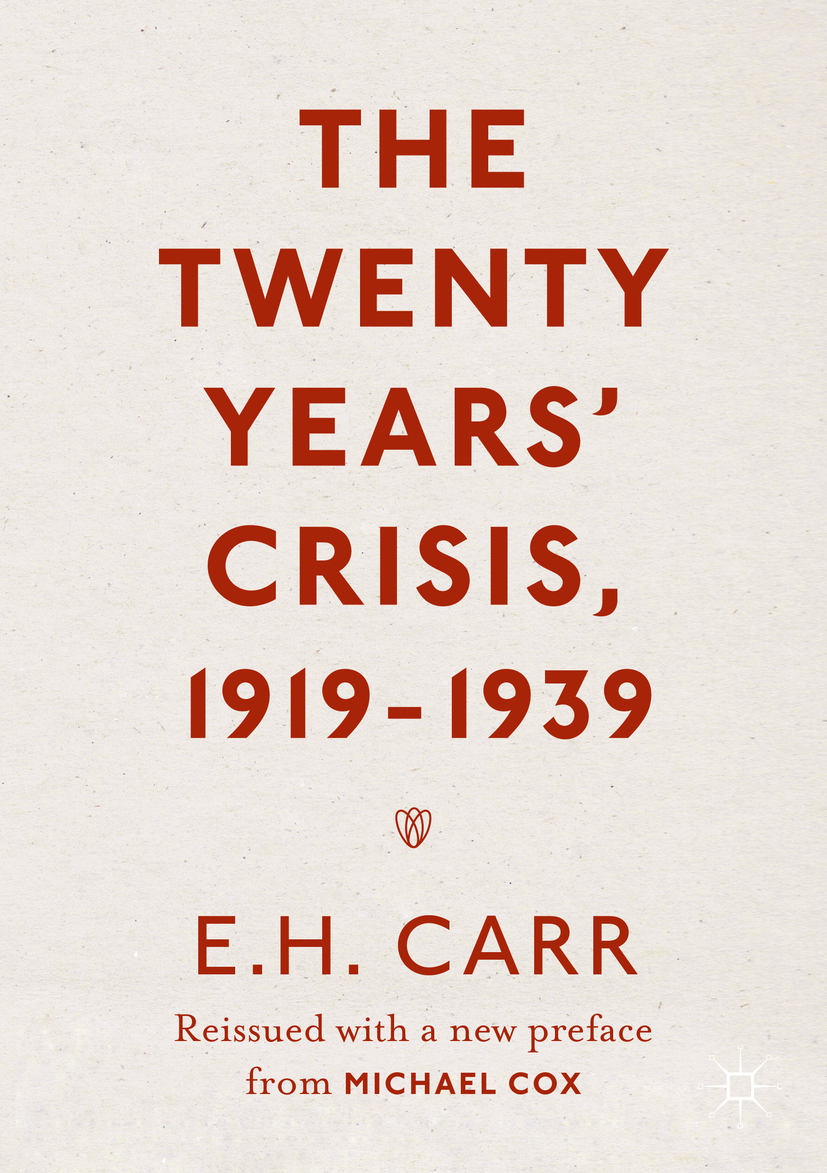
The Twenty Years' Crisis, 1919-1939 E.H. Carr's Twenty Years' Crisis is a classic work in International Relations. Published in 1939, on the eve of World War II, it was immediately recognized by friend and foe alike as a defining work in the fledgling discipline. The author was one of the most influential and controversial intellectuals of the twentieth century. The issues and themes he develops in this book continue to have relevance to modern day concerns with power and its distribution in the international system. Michael Cox's critical introduction provides the reader with background information about the author, the context for the book, its main themes and contemporary relevance. Written with the student in mind, it offers a guide to understanding a complex, but crucial text. Now updated with a new preface from Michael Cox. POLITICAL SCIENCE,General

Democratic Latin America This much-expanded and updated second edition of Democratic Latin America takes an institutional approach to Latin American politics to discuss contemporary politics and to highlight how past politics have shaped current institutional designs. It draws explicit connections between certain political features- such as fragmentation, efficiency, accountability, instability, consensus, or responsiveness- and the institutional design of a country. Students thus learn not only that a country is unstable or has high rates of participation or low levels of corruption, but they also learn why. And more importantly, they also learn how politics can be shaped by different institutional arrangements. Features: Each chapter focuses on a different institution, such as the executive, political parties, electoral systems, the armed forces, or federalism and compares how they are constructed differently across countries. Placing a premium on accessibility, each chapter opens with a story and ends with a detailed country case study, making use of contemporary examples to feed student interest in current events. Newly updated comparison-based tables and box features (electoral results, percentage of women legislators, and surveys of partisan identification) are included to stimulate analysis. New topics of research have been added to ensure the recognition of the latest changes in the region, including: corruption scandals; the turn of the "pink tide"; protest and social movements; LGBT rights; citizen security and organized crime; new forms of legislative accountability; and the use of social media as a political resource in Latin America. Democratic Latin America continues to offer an original way of teaching and learning about Latin American politics. POLITICAL SCIENCE,General

Military Intervention in the Middle East and North Africa This book contributes to an increasingly important branch of critical security studies that combines insights from critical geopolitics and postcolonial critique by making an argument about the geographies of violence and their differential impact in contemporary security practices, including but not limited to military intervention. The book explores military intervention in Libya through the categories of space and time, to provide a robust ethico-political critique of the intervention. Much of the mainstream international relations scholarship on humanitarian intervention frames the ethical, moral and legal debate over intervention in terms of a binary, between human rights and state sovereignty. In response, O’Sullivan questions the ways in which military violence was produced as a rational and reasonable response to the crisis in Libya, outlining and destabilising this false binary between the human and the state. The book offers methodological tools for questioning the violent institutions at the heart of humanitarian intervention and asking how intervention has been produced as a rational response to crisis. Contributing to the ongoing academic conversation in the critical literature on spatiality, militarism and resistance, the book draws upon postcolonial and poststructural approaches to critical security studies, and will be of great interest to scholars and graduates of critical security studies and international relations. POLITICAL SCIENCE,General
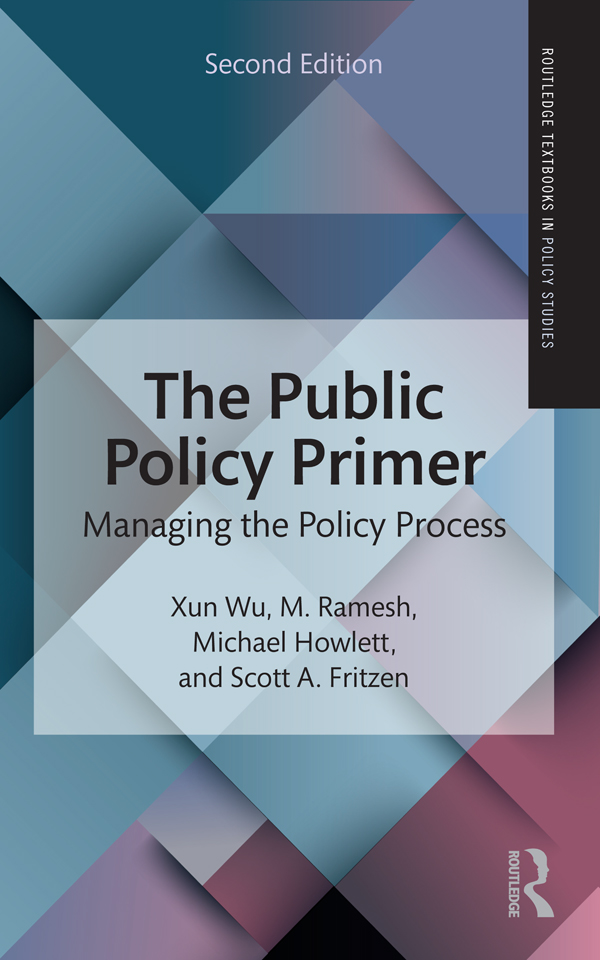
The Public Policy Primer Fully revised for a second edition, this essential guide provides a concise and accessible overview of the public policy process: agenda-setting, policy formulation, decision-making, implementation, and evaluation. The book provides an introduction to the key policy functions, the challenges they entail, and how the challenges may be addressed by policy actors. Written from a comparative perspective, the authors include examples from a diverse range of countries at different stages of development, highlighting key principles and practices through which policy actors can effectively manage their policy processes and outcomes. Key features of the second edition: fully updated and revised content throughout; expanded references and further reading; more guidance towards understanding the key concepts in public policy. This important tool offers students of public policy and policy practitioners guidance on how to make, implement, and evaluate public policies in ways that improve citizens' lives. POLITICAL SCIENCE,General
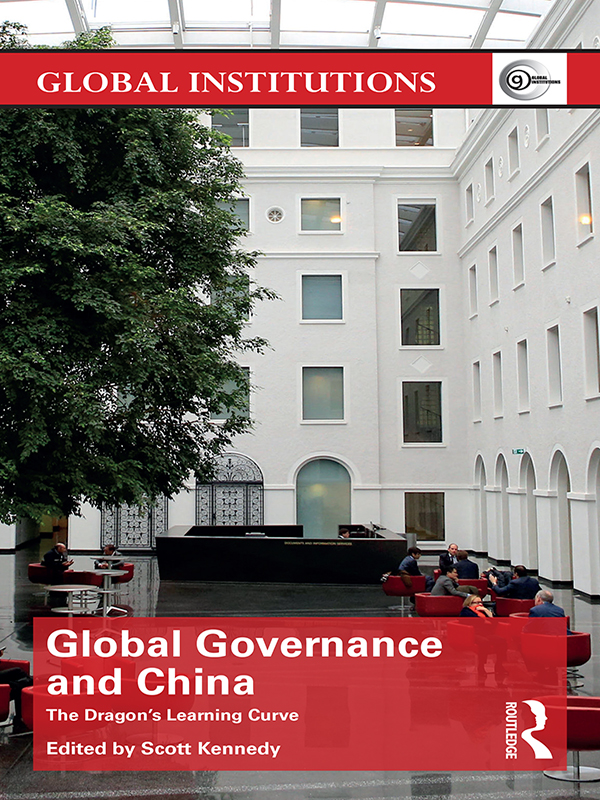
Global Governance and China This volume offers systematic analysis of China’s growing engagement in global governance institutions over the past three decades. During this period, China has gone from outsider to observer to insider. The volume is based on studies of Chinese involvement in a wide cross section of regimes, including trade, finance, intellectual property rights, foreign aid, and climate change. The contributions show that China’s participation in global governance reflects the mutually interactive processes of China’s own socialization into the global community and the simultaneous adaptation of global institutions and actors to China’s growing activism. Both China and the international system are internally complex. Hence, Chinese engagement varies across economic regimes, yielding different results in terms of Chinese compliance, its influence on regimes, and the extent of cooperation and conflict in addressing challenges in international society. The chapters reveal that China is neither purely a savior nor scofflaw of the global economic system, and while China is a defender of the status quo in some areas, it is a reformer in others, and occasionally a revisionist in still other spheres. A detailed analysis of many areas of global governance, this volume will be essential reading for students and scholars of international relations, Chinese studies and global governance. POLITICAL SCIENCE,General
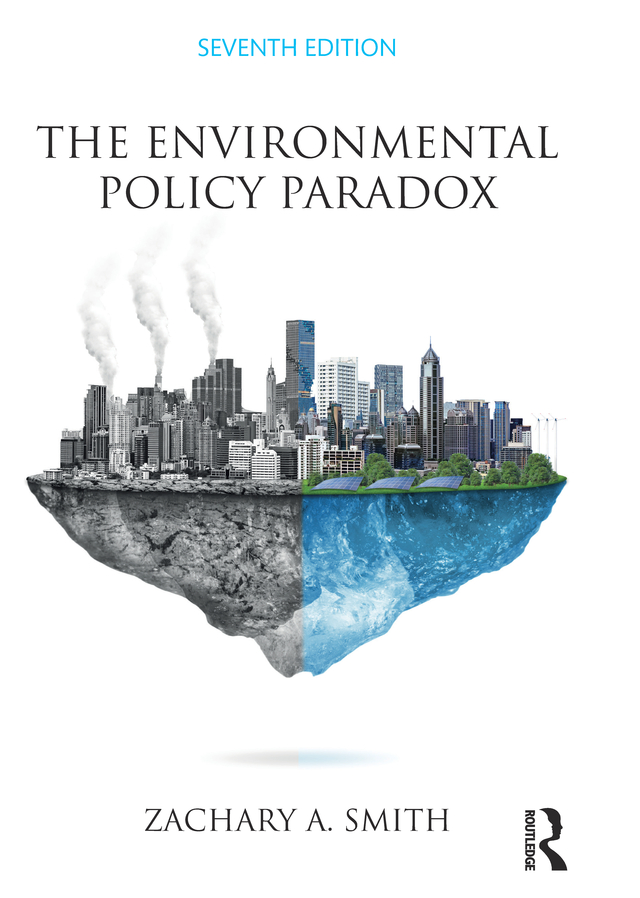
The Environmental Policy Paradox Updated in its seventh edition, The Environmental Policy Paradox provides an introduction to the policy-making process in the United States with regard to air, water, land use, agriculture, energy, and waste disposal, while introducing readers to both global and international environmental issues and institutions. The text explains why some environmental ideas shape policy while others do not, and illustrates that even when the best short- and long-term solutions to environmental problems are identified, the task of implementing these solutions is often left undone or is completed too late. Readers are presented with a comprehensive history of the environmental movement paired with the most up-to-date account of environmental policy available today. New to the Seventh Edition Covers new topics including fracking, Arctic drilling, the Keystone XL pipeline controversy, GMOs, food security, and the green economy. Provides expanded information about the subsidy process. Extends the treatment of land preservation with a discussion of the Land and Water Conservation Fund. Adds Discussion Questions to the end of each chapter. POLITICAL SCIENCE,General

Liars, Leakers, and Liberals Get the story the Fake News media doesn't want you to hear in the #1 New York Times bestseller: a withering indictment of the Deep State plot against Trump and a firsthand account of the real presidency, based on interviews with the Trump family and top administration officials. At this point in American history, we are the victims of a liberal sabotage of the presidency unlike anything we've ever witnessed. Nevertheless President Trump continues to fight every day to keep his promise to Make America Great Again. Today that bold idea has already led to a conservative judge on the Supreme Court, tax reform, and deregulation that has unleashed an economy stronger than anyone could have imagined. But there are dark forces that seek to obstruct and undermine the president and reverse the results of the 2016 presidential election. They are part of a wide-ranging conspiracy that would seem incredible if it weren't being perpetrated openly. Driven by ambition, blinded by greed, and bound by a common goal -- to unseat the 45th President of the United States -- this cabal is determined to maintain its wrongful hold on national political power. Fox News host Jeanine Pirro uncovers the elements of this conspiracy, including: "Fake news" propaganda, Law enforcement corruption at the highest levels, National security leaks by the intelligence community, Bureaucratic resistance to lawful and constitutional executive orders issued by the duly elected president, Crooked deals with foreign governments by U.S. officials sworn to defend our Constitution. It's about time the American public knows the truth about the plot to bring down the Trump presidency. By the time you've finished this book, you'll agree with Judge Pirro that the only way to stop these hoodlums is to Take Them Out in Cuffs! POLITICAL SCIENCE,General
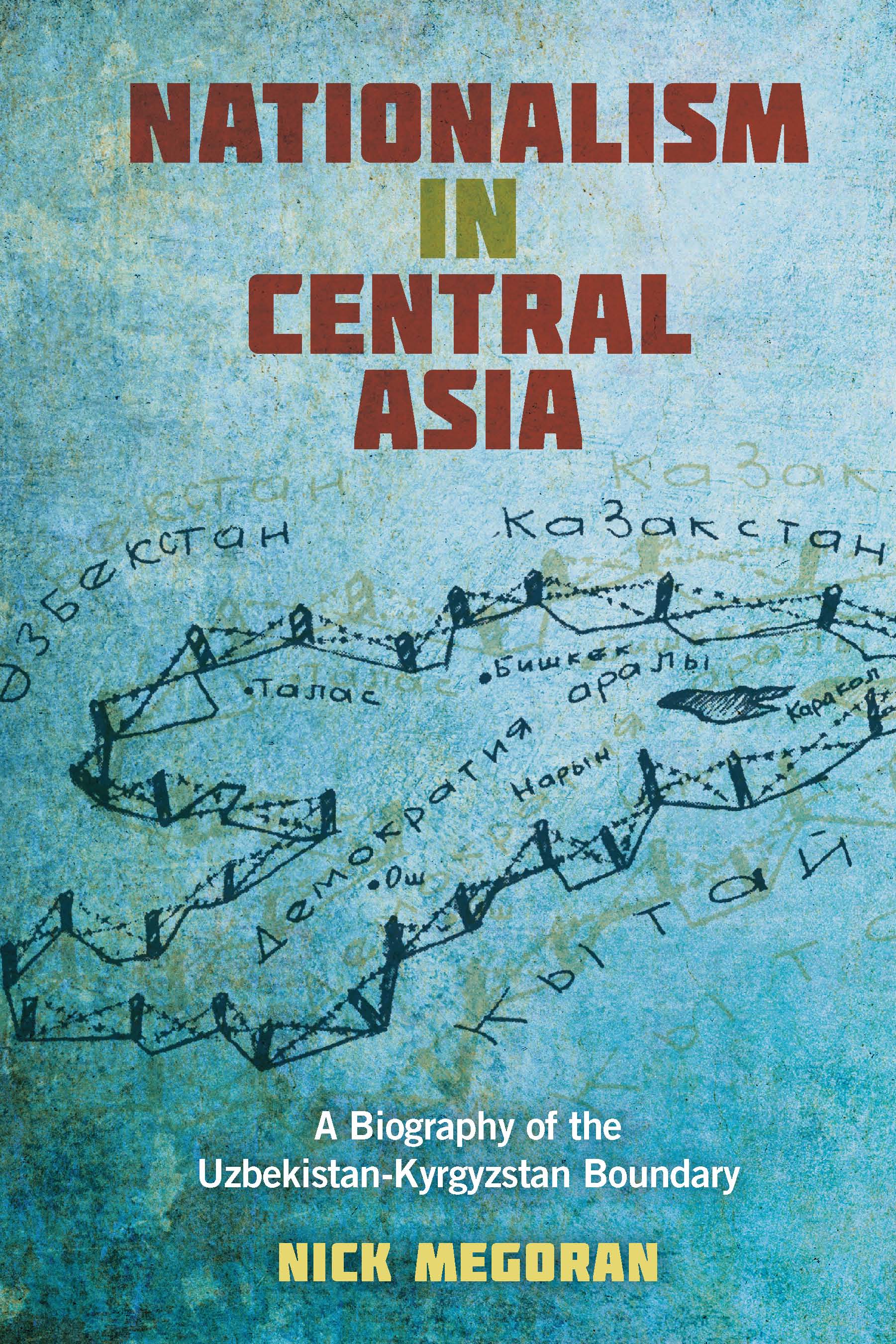
Nationalism in Central Asia Nick Megoran explores the process of building independent nation-states in post-Soviet Central Asia through the lens of the disputed border territory between Uzbekistan and Kyrgyzstan. In his rich "biography" of the boundary, he employs a combination of political, cultural, historical, ethnographic, and geographic frames to shed new light on nation-building process in this volatile and geopolitically significant region. Megoran draws on twenty years of extensive research in the borderlands via interviews, observations, participation, and newspaper analysis. He considers the problems of nationalist discourse versus local vernacular, elite struggles versus borderland solidarities, boundary delimitation versus everyday experience, border control versus resistance, and mass violence in 2010, all of which have exacerbated territorial anxieties. Megoran also revisits theories of causation, such as the loss of Soviet control, poorly defined boundaries, natural resource disputes, and historic ethnic clashes, to show that while these all contribute to heightened tensions, political actors and their agendas have clearly driven territorial aspirations and are the overriding source of conflict. As this compelling case study shows, the boundaries of the The Ferghana Valley put in succinct focus larger global and moral questions of what defines a good border. POLITICAL SCIENCE,General

Labour's Immigration Policy This book explains how and why the New Labour governments transformed Britain’s immigration system from a highly restrictive regime to one of the most expansive in Europe, otherwise known as the Managed Migration policy. It offers the first in-depth and candid account of this period of dramatic political development from the actors who made policy during ‘the making of the migrant state.’ Drawing on document analysis and over 50 elite interviews, the book sets out to explain how and why this radical policy change transpired, by examining how organized interests, political parties and institutions shaped and changed policy. This book offers valuable insights to anyone who wants to understand why immigration is dominating the political debate, and will be essential reading for those wanting to know why governments pursue expansive immigration regimes. POLITICAL SCIENCE,General

The Politics of Gun Control The new edition of this classic text covers the latest developments in American gun policy, including shooting incidents plaguing the American landscape--especially the Orlando nightclub shootings, the San Bernardino incident, and the ongoing legacy of Sandy Hook--placing them in context with similar recent events. The incidents described in the book sparked a wave of gun control legislation at local, state, and national levels, some of which was successful, some doomed and all controversial. Robert J. Spitzer has long been a recognized authority on gun control and gun policy. His even-handed treatment of the issue--as both a member of the NRA and the Brady Center--continues to compel national and international interest, including interviews by the likes of Terry Gross, Tom Ashbrook and Diane Rehm. The seventh edition of The Politics of Gun Control provides the reader with up-to-date data and coverage of gun ownership, gun deaths, school shootings, border patrols and new topics including social media, stand-your-ground laws, magazine regulation, and shooting-related mental health initiatives. New to the Seventh Edition Reports on the pivotal 2016 elections, including the rise and victory of one-time gun control supporter-turned gun rights advocate Donald Trump. The latest data on gun ownership and use, revealing contradictory trends. New developments in the push to allow civilian gun carrying on college campuses, the controversy over so-called "gun-free zones," and a new examination of restrictions imposed on the Centers for Disease Control. POLITICAL SCIENCE,General

Let Trump Be Trump A New York Times Bestseller and #1 Wall Street Journal Bestseller! Let Trump be Trump: The Inside Story of His Presidency is the ultimate behind-the-scenes account of how he became President of the United States. Donald Trump was a candidate, and now a president, like none that have come before. His startling rise to the White House is the greatest political tale in the history of our republic. Much has been written about this once-in-a-millennial event but all of those words come from authors outside the orbit of Donald Trump. Now, for the first time, comes the inside story. Written by the guys in the room-two of Trump's closest campaign advisors-Let Trump Be Trump is the eyewitness account of the stories behind the headlines. From the Access Hollywood recording and the Clinton accusers, to Paul Manafort, to the last-moment comeback and a victory that reads like something out of the best suspense novel, Let Trump Be Trump pulls back the curtain on a drama that has mesmerized the whole world-including the palace intrigues of the Mooch, Spicer, Preibus, Bannon, and more. By turns hilarious and intimate, Let Trump Be Trump also offers a view of Donald Trump like you've never seen him, the man whose success in business was built not only on great skill but on loyal relationships and who developed the strongest of bonds with the band of outsiders and idealists who became his team because they believed in him and his message. Written by Trump's campaign manager, the fiery Corey Lewandowski, and Dave Bossie, the consummate political pro and the plaintiff in the famous Citizens United Supreme Court case who helped steer the last critical months of the Trump campaign, Let Trump Be Trump is destined to be the seminal book about the Trump campaign and presidency. POLITICAL SCIENCE,General
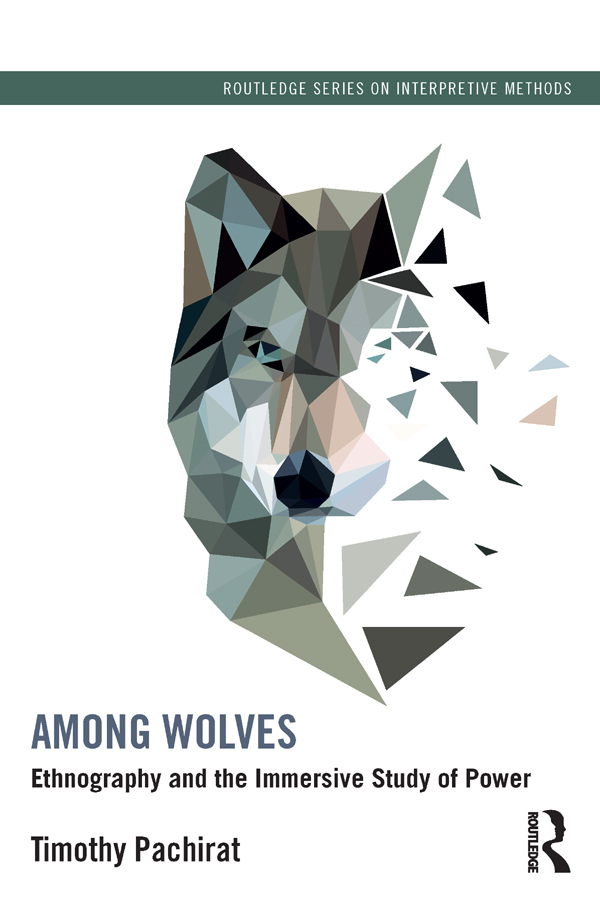
Among Wolves Summoned by an anonymous Prosecutor, ten contemporary ethnographers gather in an aging barn to hold a trial of Alice Goffman’s controversial ethnography, On the Run. But before the trial can get underway, a one-eyed wolfdog arrives with a mysterious liquid potion capable of rendering the ethnographers invisible in their fieldsites. Presented as a play that unfolds in seven acts, the ensuing drama provides readers with both a practical guide for how to conduct immersive participant-observation research and a sophisticated theoretical engagement with the relationship between ethnography as a research method and the operation of power. By interpolating "how-to" aspects of ethnographic research with deeper questions about ethnography’s relationship to power, this book presents a compelling introduction for those new to ethnography and rich theoretical insights for more seasoned ethnographic practitioners from across the social sciences. Just as ethnography as a research method depends crucially on serendipity, surprise, and an openness to ambiguity, the book’s dramatic and dialogic format encourages novices and experts alike to approach the study of power in ways that resist linear programs and dogmatic prescriptions. The result is a playful yet provocative invitation to rekindle those foundational senses of wonder and generative uncertainty that are all too often excluded from conversations about the methodologies and methods we bring to the study of the social world. POLITICAL SCIENCE,General

Global Perspectives on Same-Sex Marriage This book provides a comparative, neo-institutionalist approach to the different factors impacting state adoption of—or refusal to adopt—same-sex marriage laws. The now twenty-one countries where lesbians and gay men can legally marry include recent or longstanding democracies, republics and parliamentary monarchies, and unitary and federal states. They all reflect different positions with respect to religion and the cultural foundations of the nation. Countries opposed to such legalization, and those having taken measures in recent years to legally reinforce the heterosexual fundaments of marriage, present a similar diversity. This diversity, in a globalized context where the idea of same-sex marriage has become integral to claims for LGBTI equality and indeed LGBTI human rights, gives rise to the following question: which factors contribute to institutionalizing same-sex marriage? The analytical framework used for exploring these factors in this book is neo-institutionalism. Through three neo-institutionalist lenses—historical, sociological and discursive—contributors investigate two aspects of the processes of adoption or opposition of equal recognition of same-sex partnerships. Firstly, they reveal how claims by LGBTIQ movements are being framed politically and brought to parliamentary politics. Secondly, they explore the ways in which same-sex marriage becomes institutionalized (or resisted) through legal and societal norms and practices. Although it adopts neo-institutionalism as its main theoretical framework, the book incorporates a broad range of perspectives, including scholarship on social movements, LGBTI rights, heterosexuality and social norms, and gender and politics. POLITICAL SCIENCE,General

Why Parties Matter Since the founding of the American Republic, the North and South have followed remarkably different paths of political development. Among the factors that have led to their divergence throughout much of history are differences in the levels of competition among the political parties. While the North has generally enjoyed a well-defined two-party system, the South has tended to have only weakly developed political parties—and at times no system of parties to speak of. With Why Parties Matter, John H. Aldrich and John D. Griffin make a compelling case that competition between political parties is an essential component of a democracy that is responsive to its citizens and thus able to address their concerns. Tracing the history of the parties through four eras—the Democratic-Whig party era that preceded the Civil War; the post-Reconstruction period; the Jim Crow era, when competition between the parties virtually disappeared; and the modern era—Aldrich and Griffin show how and when competition emerged between the parties and the conditions under which it succeeded and failed. In the modern era, as party competition in the South has come to be widely regarded as matching that of the North, the authors conclude by exploring the question of whether the South is poised to become a one-party system once again with the Republican party now dominant. POLITICAL SCIENCE,General

Power, Perception and Foreign Policymaking This book examines the changing dynamics of power in the international arena since the end of the Cold War. Brown engages in analysis of how the United States and the European Union have responded to the so-called rise of China through an examination of how policymakers’ perceptions of China have changed over time and influenced their policy choices. This study undertakes rigorous analysis of how these perceptions have evolved between 1989 and 20092016, offering a comparative perspective on the similarities and differences between the policy discourse and behaviour within these two Western powers. Brown argues that ‘China’s rise’ is a contested notion, with varied perceptions of how the implications of China’s ascendancy have shaped policy preferences in ways that are inconsistent with concerns over the threat of an impending power-transition. Combining concepts and methods derived from IR and FPA, the book examines the linkages between great power politics and policymakers’ competing interpretations of key international actors, and their influence upon foreign policies. The main objective of the study is to illuminate the different ways in which the US and the EU have responded to the rise of China through a close analysis of their decision-making processes and outcomes across a series of key encounters and events, including the transatlantic debate over the EU’s proposal to lift its China arms embargo (2003-2005). Undertaking qualitative analysis of the development of American and European policymakers’ perceptions of China, this book will be of interest to graduates and scholars of post-Cold War international politics, Foreign Policy Analysis, policymaking, US-China relations and EU-China relations. POLITICAL SCIENCE,General
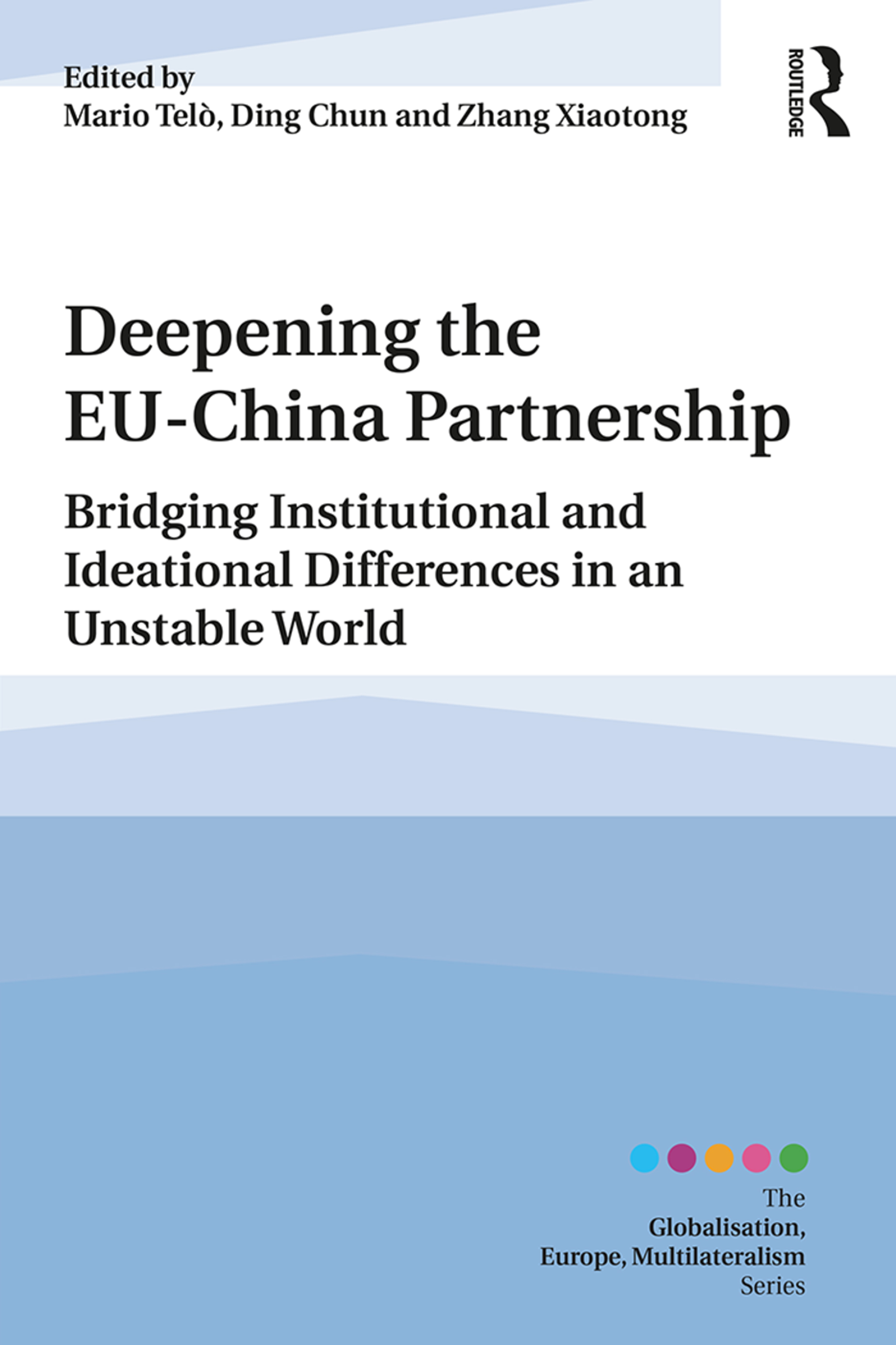
Deepening the EU-China Partnership The China-EC/EU relationship, started in 1975, is a highly institutionalized, multidimensional and complex, but to some extent controversial international partnership. It is also challenged within the current unstable world. This book addresses the convergences and the differences (ideational, political, institutional and interests-related) between China and the EU by a collective interaction between Chinese and European scholars. Among other things the book assesses sectoral bilateral dialogue and focuses on the interplay between internal complexity and external policies, discusses ideational divergences in international law and rule of law and in many relevant policy fields. Furthermore, it compares sustainable growth policies; explores trade and investment controversies and negotiations, human rights dialogue; and addresses environment and climate change policies. This text will be of key interest to EU studies and politics, China studies and more broadly to area/Asian studies and international relations/global governance. POLITICAL SCIENCE,General
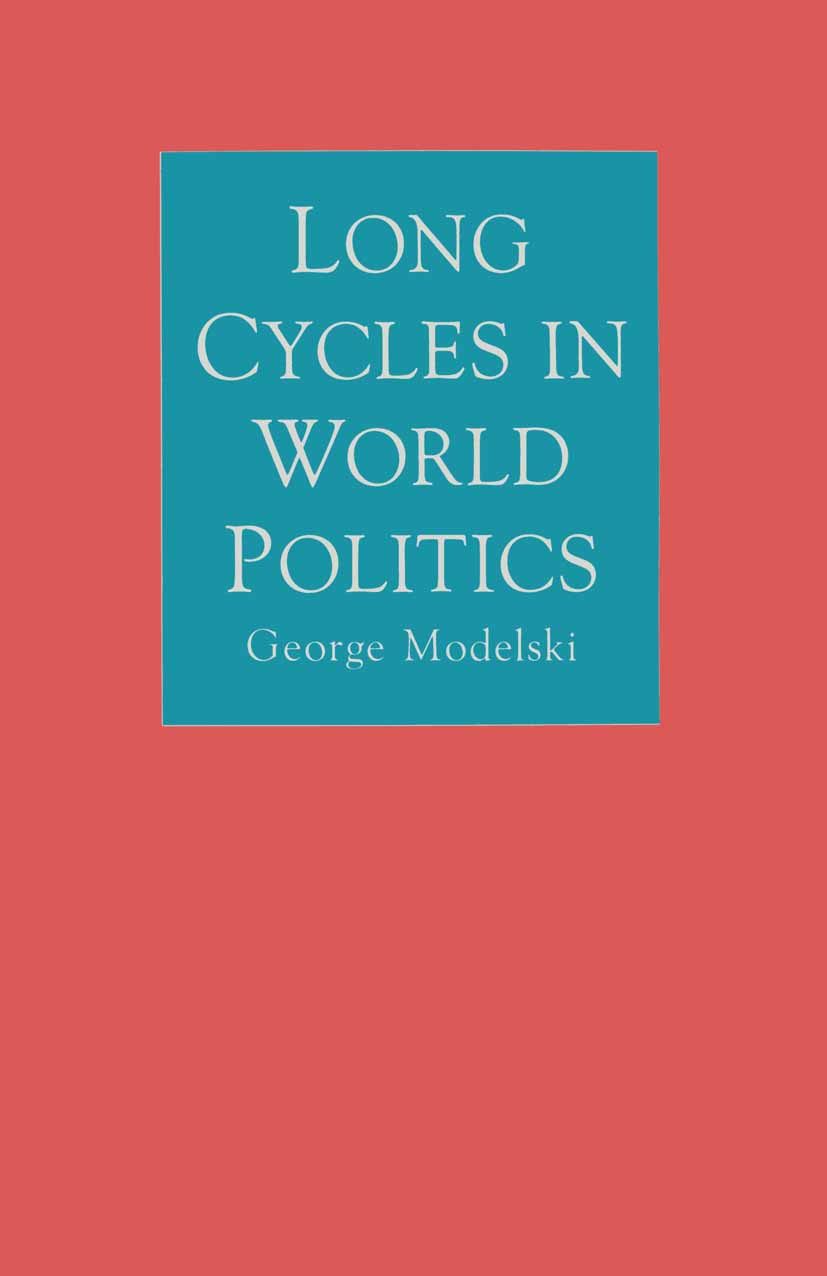
Long Cycles in World Politics POLITICAL SCIENCE,General

The President as Leader By analyzing the leadership skills of seven recent American presidents, this book seeks to de-mystify the elements and dynamics of effective presidential leadership which our democracy has come to depend upon and value. Building on the pioneering work of political scientist Fred Greenstein and others, this book argues that leadership in the White House can be explained and assessed by using a consistent set of criteria to analyze presidential performance. Siegel shows that presidential leadership is exercised by real, flawed human beings, and not by superheroes or philosopher-kings beyond the reach of scrutiny or critique. New to the Second Edition Includes a new chapter covering both terms of the Obama administration. Applies the author’s four-part leadership framework to the early part,of the Trump administration. Discusses the possibilities of presidential leadership in an era of intense partisanship. POLITICAL SCIENCE,General

Campaigns and Elections Stephen Medvic’s Campaigns and Elections is a comprehensive yet compact core text that addresses two distinct but related aspects of American electoral democracy—both the processes that constitute campaigns and elections and the players who are involved. In addition to balanced coverage of process and actors, it also gives equal billing to both campaigns and elections, and covers contests for legislative and executive positions at the national and state and local levels, including issue-oriented campaigns of note. The book opens by providing students with the conceptual distinctions between what happens in an election and the campaigning that precedes it. Significant attention is devoted to setting up the context for these campaigns and elections by covering the rules of the game in the American electoral system as well as aspects of election administration and the funding of elections. Then the book systematically covers the actors at every level—candidates and their organizations, parties, interest groups, the media, and voters—and the macro level aspects of campaigns such as campaign strategy and determinants of election outcomes. The book concludes with a big picture assessment of campaign ethics and implications of the "permanent campaign". New to the Third Edition Fully updated through the 2016 elections. Questions the "party decides" theory of the nomination process in light of the Trump Republican candidacy. Covers campaign finance laws and practice emanating from both Citizens United and McCutcheon. Critically examines restrictive voting laws in place for the first time in the 2016 presidential election. Looks at new automatic voter registration as well as registration removals. Expands coverage of media effects on campaigns at every stage, including social media. Draws upon recent research on new campaign technologies and of the science of campaigning. POLITICAL SCIENCE,General
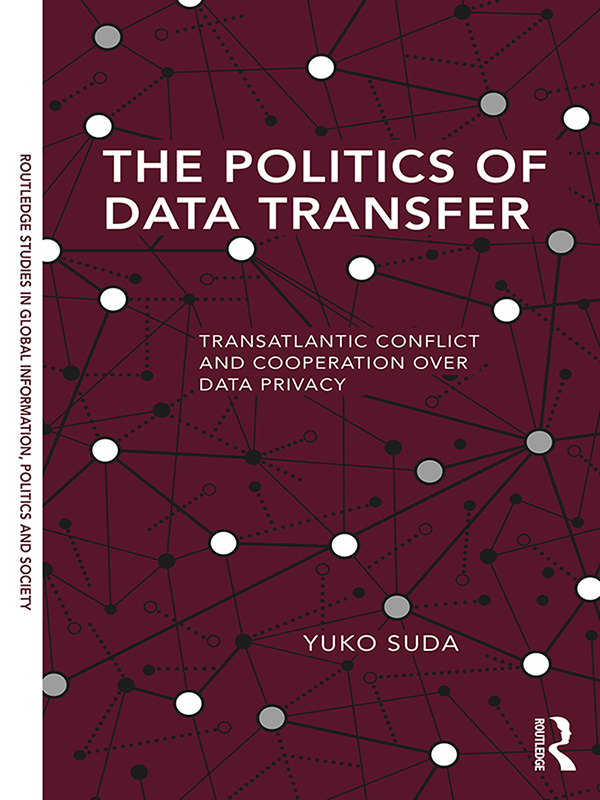
The Politics of Data Transfer In this book, Yuko Suda examines the Safe Harbor debate, the passenger name record (PNR) dispute, and the Society for Worldwide Interbank Financial Transactions (SWIFT) affair to understand the transfer of personal data from the European Union (EU) to the United States. She argues that the Safe Harbor, PNR, and SWIFT agreements were made to mitigate the potentially negative effects that may arise from the beyond-the-border reach of EU data protection rules or US counterterrorism regulation. A close examination of these high-profile cases would reveal how beyond-the-border reach of one jurisdiction’s regulation might affect another jurisdiction’s policy and what responses the affected jurisdiction possibly makes to manage the effects of such extraterritorial regulation. The Politics of Data Transfer adds another dimension to the study of transatlantic data conflicts by assuming that the cases exemplify not only the politics of data privacy but also the politics of extraterritorial regulation. A welcome and timely collection uncovering the evolution of and prospects for the politics of data privacy in the digitalized and interconnected world. POLITICAL SCIENCE,General

Public Personnel Management Now in a thoroughly revised 7th edition, Public Personnel Management focuses on the critical issues and common processes in the management of public sector personnel. In keeping with prior editions, the text centers on the core processes within public human resource management: strategic workforce planning, effective recruitment and retention, workforce development, and employee relations. Designed to further address the ways in which expectations for human resource managers have changed and developed in recent years, the 7th edition includes several new features and improvements: Substantially restructured, updated, and additional case studies and student exercises. Coverage of how the field of Public HRM has been influenced by the two most recent national recessions, economic downturns at the state and local level, privatization and contracting trends at all levels of government, the growing presence of millennial employees in the workplace, issues surrounding social media use within the workplace, the evolving goals of social equity and diversity, and the shifting role and influence of labor unions. Discussions of how the growth in information technology capabilities has influenced the major processes within HRM, from workforce analysis through big data analytics to the explosion in automated recruitment, assessment, and instructional technologies. For the first time, the text includes an online Instructor's Manual, PowerPoint slides, discussion questions, and suggestions for further reading to make it even easier to assign and use this classic text in the classroom. Providing the most up-to-date and thorough overview of the history and practice of public human resource management for both undergraduate and graduate students, Public Personnel Management, 7e remains the beloved text it ever was, ideal for introductory courses in Public Personnel Management, Public Human Resource Management, and Nonprofit Personnel Management. POLITICAL SCIENCE,General

Seeing Like an International Organization This book contributes to the study of International Organizations (IOs) by providing a sharp focus on how IOs’ "analytic institutions" interact with states over key policy issues. Analytic institutions include the areas, departments, committees, adjudicatory bodies, and others housed by or linked to IOs that develop the cognitive framework for identifying, understanding, and solving policy problems. Analytic institutions make the state "legible" to IOs and are the key means for how IOs "see" their member states, shaping how international political and economic problems are understood. This book investigates why seeing like an IO matters through cases on leading organizations for global economic governance, including the International Monetary Fund, the World Bank, the Bank for International Settlements, the Organisation for Economic Co-Operation and Development, and the World Trade Organization. The contributors demonstrate the benefits of studying IOs "from the inside-out" to enrich our understanding of why issues in the international political economy are governed the way they are. This book was published as a special issue of New Political Economy. POLITICAL SCIENCE,General

International Organization and Global Governance Completely revised and updated for the second edition, this textbook continues to offer the most comprehensive resource available for all interested in international organization and global governance. The book offers: In-depth and accessible coverage of the history and theories of international organization and global governance. Discussions of the full range of state, intergovernmental, and non-state actors. Examinations of key issues in all aspects of contemporary world politics. New additions to this edition include: New and revised chapters on theories of international organization and global governance. New substantive chapters on global corporations, China, financial markets, terrorist organizations, governing global energy, and the Internet. Updated contributions to reflect the changing nature of world politics. The book comprises fifty-four chapters arranged in seven parts and woven together by a comprehensive introduction to the field, along with separate introductions to each part to guide students and faculty, and helpful pointers to further reading. International Organization and Global Governance is a self-contained resource enabling readers to comprehend more fully the role of myriad actors in the governance of global life as well as to assemble the many pieces of the contemporary global governance puzzle. POLITICAL SCIENCE,General

Marriage Trafficking This book examines the traffic in women for marriage, a phenomenon that has been largely overlooked in international efforts to address the problem of human trafficking. In contrast to current international and state-based approaches to trafficking, which tend to focus on sex trafficking and trafficking for forced labour, this book seeks to establish how marriage as an institution is often implicated in the occurrence of trafficking in women. The book aims firstly to establish why marriage has tended not to be included in dominant conceptions of trafficking in persons and secondly to determine whether certain types of marriage may constitute cases of human trafficking, in and of themselves. Through the use of case studies on forced marriage, mail-order bride (MOB) marriage and Fundamentalist Mormon polygamy, this book demonstrates that certain kinds of marriage may in fact constitute situations of trafficking in persons and together form the under-recognised phenomenon of ‘marriage trafficking’. In addition, the book offers a new perspective on the types of harm involved in trafficking in women by developing a framework for identifying the particular abuses characteristic to marriage trafficking. It argues that the traffic in women for marriage cannot be understood merely as a subset of sex trafficking or trafficking for forced labour, but rather constitutes a distinctive form of trafficking in its own right. This book will be of great interest to scholars and postgraduates working in the fields of human rights theory and institutions, political science, international law, transnational crime, trafficking in persons, and feminist political theory. POLITICAL SCIENCE,General

Covenant and Civil Society The essence of the covenant tradition is the idea of human beings freely associating for common purposes through pacts of mutual commitment. In the political realm, the idea of covenant has been particularly influential in frontierlands. Reinformed by the idea of the federated commonwealth that emerged out of the Protestant Reformation, covenant eventually fostered the establishment of the United States of America and our modern idea of federalism. More recently, these great products of the covenant tradition helped to bring about the collapse of twentieth-century totalitarianism and fueled a new spirit in contemporary political life throughout the world. A return to political covenantalism seems to be an appropriate response to the crisis of modern civilization and the new epoch after World War II. Covenant and Civil Society is the final volume in Elazar's monumental series The Covenant Tradition in Politics. In it, he traces the tradition's rebirth and development in the modern epoch.Covenant and Civil Society also considers issues of communal solidarity on a postmodern basis. Elazar traces the transition from the covenanted commonwealth of the Protestant Reformation to the civil society of the modern epoch, and explores the covenant's role in the modern statist era and the development of modern democracy. Scandiriavia, and the Latin-Germanic borderlands, many of which are typically thought of as examples of organic or hierarchical models. Elazar argues that a covenantal model is more appropriate and is part of the Western tradition as such.The book concludes with examination of the present and future of covenantal thought. Today, the global spread of federalism, most clearly seen in the formation of the European Union, is also seen in local and private arenas. Elazar considers the benefits of covenantal thought while balancing such optimism with a realistic sense of its limits. As a prescription for change, Covenant and Civil Society is a fundamental and original contribution. Along with the previous volumes in this series, all available from Transaction, it will be of deep interest to historians, social scientists, political theorists, and theologians of all persuasions. POLITICAL SCIENCE,General
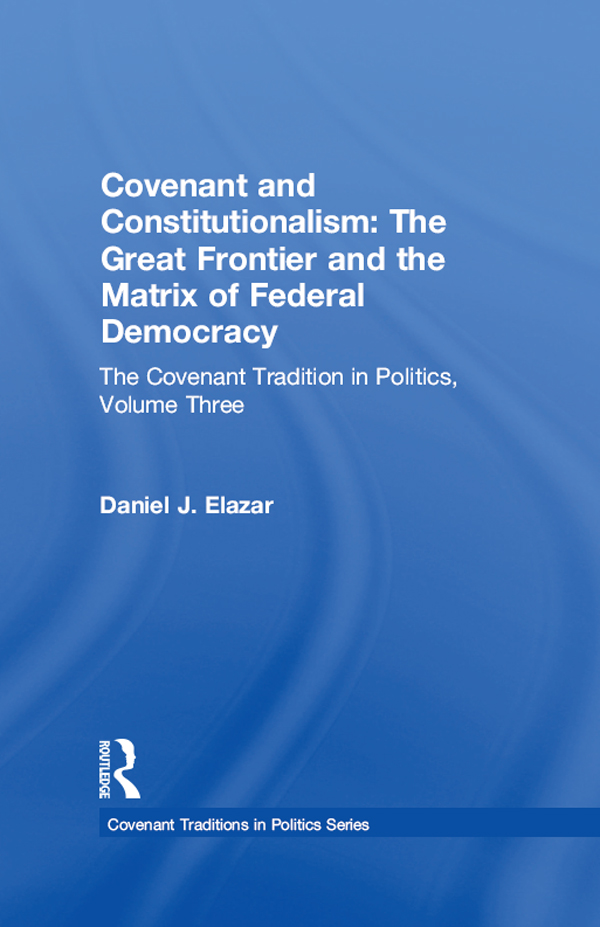
Covenant and Constitutionalism This volume traces the trends and the developing relationships of constitutionalism and covenant that ultimately led to the transformation of the latter into the former. Elazar explores the paths that emerged out of the constitutionalized covenantal tradition in Europe such as federalism, communitarianism, and the cooperative movement. POLITICAL SCIENCE,General

Growing Pains We are now living in a world where Brexit and Trump are daily realities. But how did this come about? And what does it mean for the future? Populism and ultra-nationalism brought about the rise of Hitler and Mussolini in the 1930s. Now, as Trump sits in the White House, Britain negotiates its way out of the EU, and countries across Europe see substantial gains in support for the extreme Right, award-winning journalist, author, and historian Gwynne Dyer asks how we got here, and where we go next. Dyer examines the global challenges facing us all today and explains how they have contributed to a world of inequality, poverty, and joblessness — conditions which he argues inevitably lead to the rise of populism. The greatest threat to social and political stability, he argues, lies in the rise of automation, which will continue to eliminate jobs, whether politicians admit that it is happening or not. To avoid a social and political catastrophe, we will have to find ways of putting real money into the pockets of those who have no work. But this is not a book without hope. Our capacity for overcoming the worst has been tested again and again throughout history, and we have always survived. To do so now, Dyer argues, we must embrace radical solutions to the real difficulties facing individuals, or find ourselves back in the 1930s with no way out. POLITICAL SCIENCE,General

Security Studies Security Studies: An Introduction, 3rd edition, is the most comprehensive textbook available on the subject, providing students with an essential grounding in the debates, frameworks, and issues on the contemporary security agenda. This new edition has been comprehensively revised and updated, with new chapters added on poststructuralism, postcolonialism, securitization, peace and violence, development, women, peace and security, cybersecurity, and outer space. Divided into four parts, the text provides students with a detailed, accessible overview of the major theoretical approaches, key themes, and most significant issues within security studies. Part 1 explores the main theoretical approaches from both traditional and critical standpoints Part 2 explains the central concepts underpinning contemporary debates Part 3 presents an overview of the institutional security architecture Part 4 examines some of the key contemporary challenges to global security Collecting these related strands into a single textbook creates a valuable teaching tool and a comprehensive, accessible learning resource for undergraduates and MA students. POLITICAL SCIENCE,General
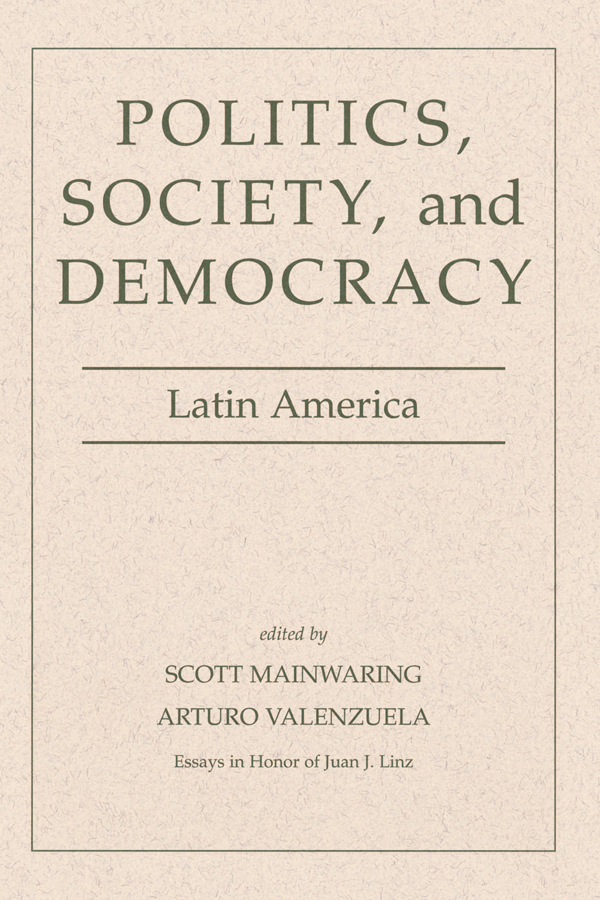
Politics, Society, And Democracy Latin America This is the third of four volumes compiled in honor of Juan J. Linz and edited by H. E. Chehabi, Richard Gunther, Alfred Stepan, and Arturo Valenzuela. Each volume presents original research and theoretical essays by Linz's distinguished collaborators, students, teachers, and friends, as well as overviews of his enormous contributions to Spanish and Latin American studies, comparative politics, and sociology.In Volume III, leading Latin American scholars evaluate Juan Linz's contribution to the study of Latin American politics, in particular his influence on studies dealing with authoritarianism, democratic breakdown, public opinion, regime transition, and the institutional conditions needed for stable democracy. POLITICAL SCIENCE,General
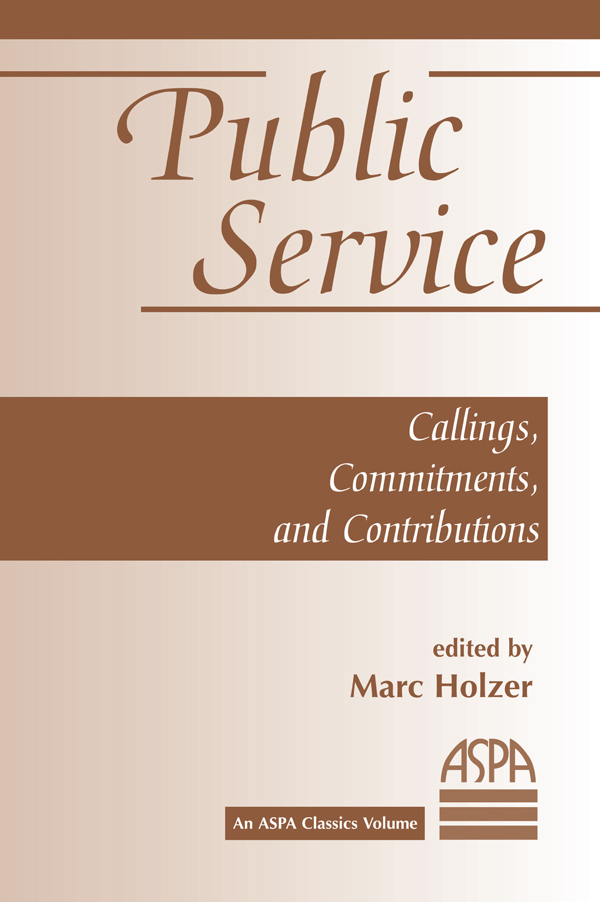
Public Service This volume includes perspectives on public service selected from six decades of major public administration journals. Recurring themes include: motivations to enter the public service, positive and negative images of public servants and of government, conflicts between loyalty to the organization and loyalty to the public, morale, burnout, and turnover. The volume also includes cross-national analyses of the public service in other systems, proposals for rethinking public service systems, and questions as to the future of the public service. It recaptures a long, continuing debate as to the health of the public service, and in so doing suggests agendas for university research and administrative action. POLITICAL SCIENCE,General
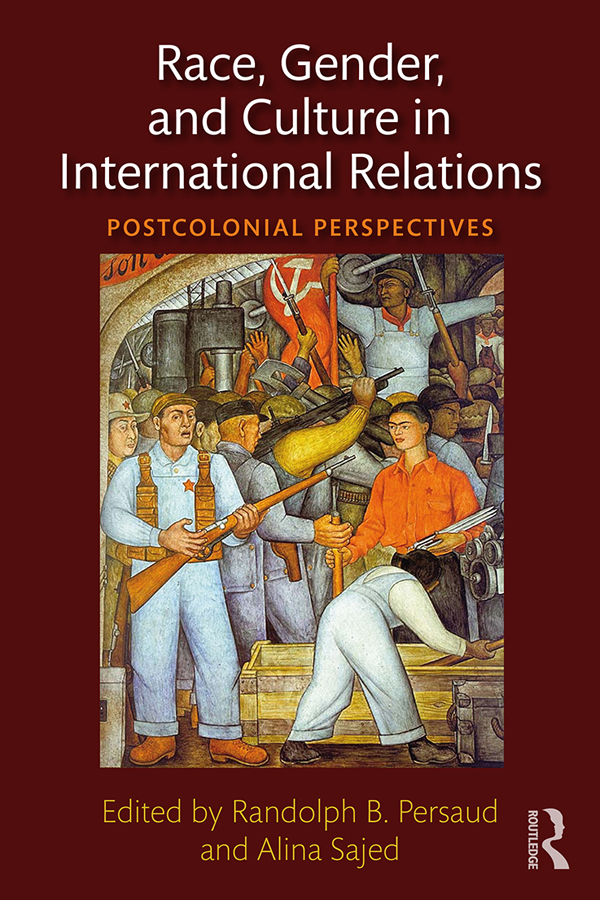
Race, Gender, and Culture in International Relations International relations theory has broadened out considerably since the end of the Cold War. Topics and issues once deemed irrelevant to the discipline have been systematically drawn into the debate and great strides have been made in the areas of culture/identity, race, and gender in the discipline. However, despite these major developments over the last two decades, currently there are no comprehensive textbooks that deal with race, gender, and culture in IR from a postcolonial perspective. This textbook fills this important gap. Persaud and Sajed have drawn together an outstanding lineup of scholars, with each chapter illustrating the ways these specific lenses (race, gender, culture) condition or alter our assumptions about world politics. This book: covers a wide range of topics including war, global inequality, postcolonialism, nation/nationalism, indigeneity, sexuality, celebrity humanitarianism, and religion; follows a clear structure, with each chapter situating the topic within IR, reviewing the main approaches and debates surrounding the topic and illustrating the subject matter through case studies; features pedagogical tools and resources in every chapter - boxes to highlight major points; illustrative narratives; and a list of suggested readings. Drawing together prominent scholars in critical International Relations, this work shows why and how race, gender and culture matter and will be essential reading for all students of global politics and International Relations theory. POLITICAL SCIENCE,General
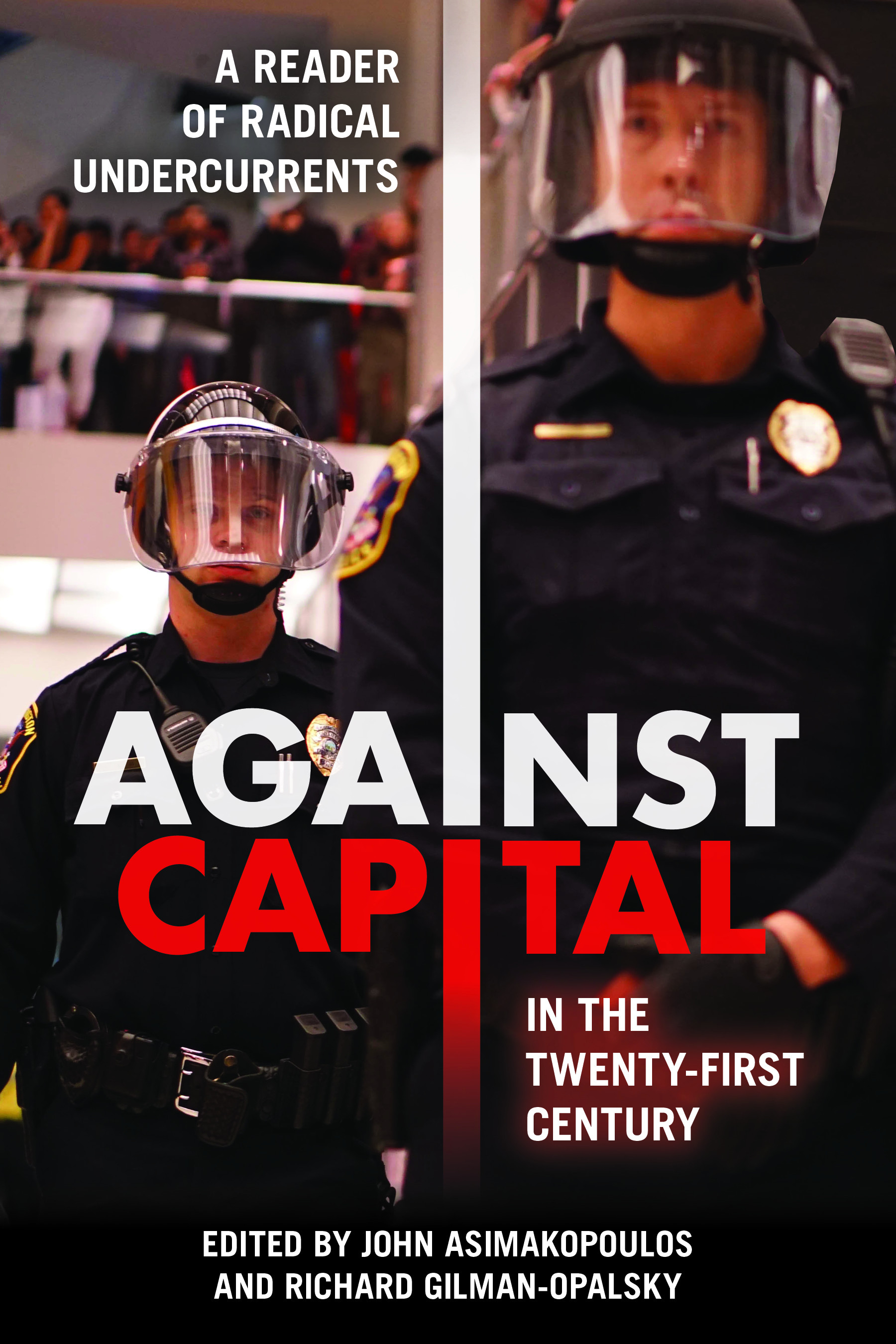
Against Capital in the Twenty-First Century The problems of capitalism have been studied from Karl Marx to Thomas Piketty. The latter has recently confirmed that the system of capital is deeply bound up in ever-growing inequality without challenging the continuance of that system. Against Capital in the Twenty-First Century presents a diversity of analyses and visions opposed to the idea that capital should have yet another century to govern human and non-human resources in the interest of profit and accumulation. The editors and contributors to this timely volume present alternatives to the whole liberal litany of administered economies, tax policy recommendations, and half-measures. They undermine and reject the logic of capital, and the foregone conclusion that the twenty-first century should be given over to capital just as the previous two centuries were. Providing a deep critique of capitalism, based on assessment from a wide range of cultural, social, political, and ecological thinking, Against Capital in the Twenty-First Century insists that transformative, revolutionary, and abolitionist responses to capital are even more necessary in the twenty-first century than they ever were. POLITICAL SCIENCE,General
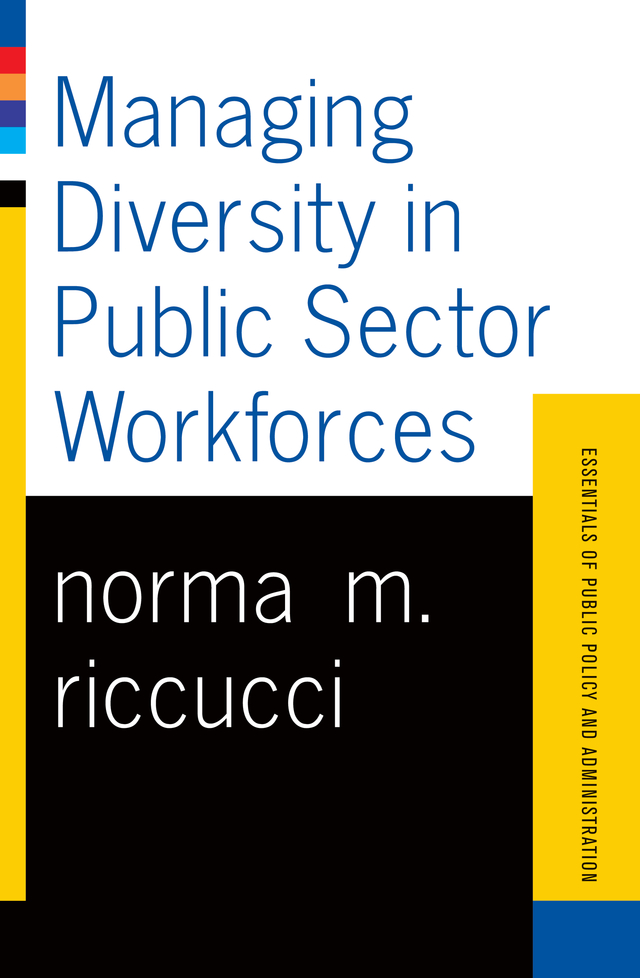
Managing Diversity In Public Sector Workforces Addresses increased diversity in government work forces, and management strategies appropriate for managing diversity. Today, public employers are poised to create productive work forces that are represented of the global population. As we enter the twenty-first century, Americas workforce looks markedly different than it ever has before. Compared with even twenty years ago, more white women, people of color, disabled persons, new and recent immigrants, gays and lesbians, and intergenerational mixes now work in America. The way in which government employers embrace this opportunity of diversity will clearly distinguish effective and efficient organizations from those which are unproductive and unable to meet the demands and necessities of the American people in the new century. This book addresses the demographic changes to the labor force and workplace and the ways in which government employers are managing the imminently diverse populations that now fill public sector jobs. It addresses the specific management strategies and initiatives relied upon by public sector employers as well as the implications of effectively managing variegated workforces for the overall governance of American society. POLITICAL SCIENCE,General
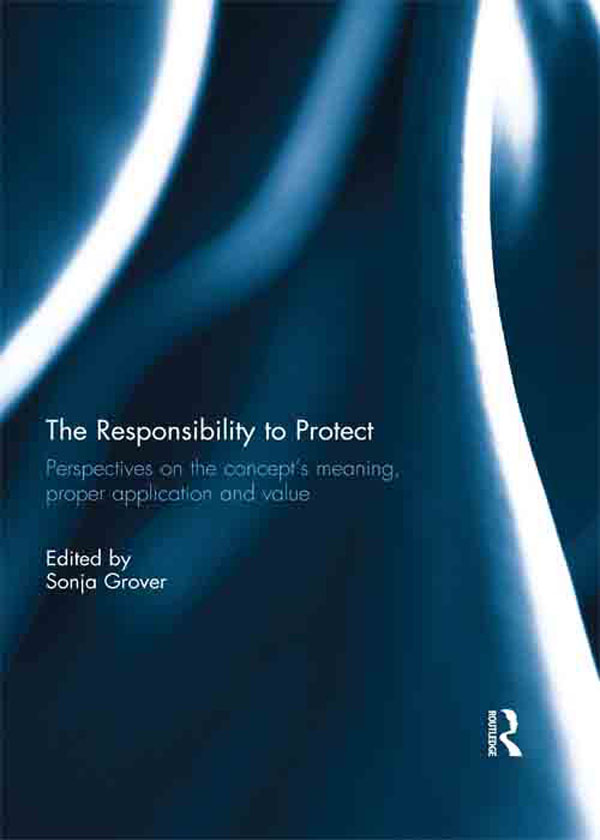
The Responsibility to Protect This book presents the views of various international law and human rights experts on the contested meaning, scope of application, value and viability of R2P; the principle of the Responsibility to Protect . R2P refers to the notion that the international community has a legal responsibility to protect civilians against the potential or ongoing occurrence of the mass atrocity crimes of genocide, large scale war crimes, ethnic cleansing and crimes against humanity. R2P allows for intervention where the individual State is unable or unwilling to so protect its people or is in fact a perpetrator. The book addresses also the controversial issue of whether intervention by States implementing R2P with or without the endorsement of the United Nations Security Council constitutes a State act of aggression or instead is legally justified and not an infringement on the offending State’s sovereign jurisdiction. The adverse impact on global peace and security of the failure to protect civilians from mass atrocity crimes has put in stark relief the need to address anew the principle of ‘responsibility to protect’ and the feasibility and wisdom of its application and this book is a significant contribution to that effort. This book was originally published as a special issue of the International Journal of Human Rights. POLITICAL SCIENCE,General
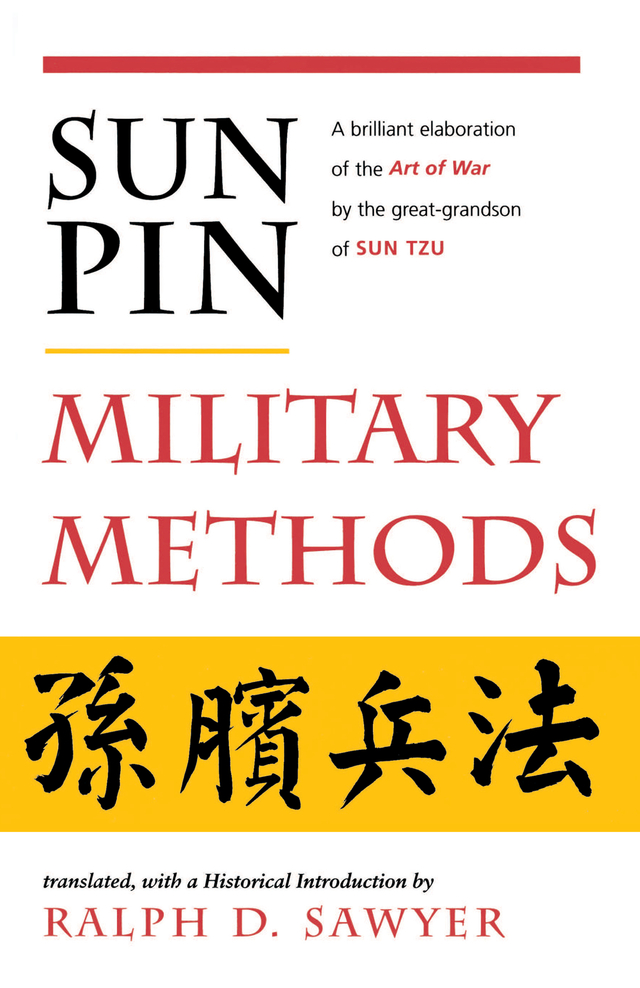
Sun Pin A description of the awesome army commanded by Sun Pin, a direct descendent of the legendary Sun Tzu. This translation comments on Sun Pin's life and times. It analyzes in detail Sun Pin's tactics in battles, and compares his strategic thinking with that of Sun Tzu. POLITICAL SCIENCE,General
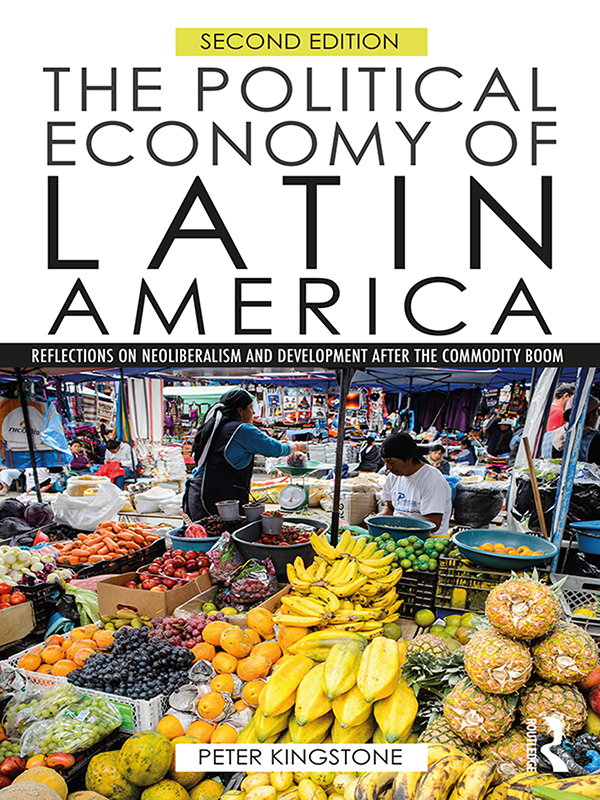
The Political Economy of Latin America This brief text offers an unbiased reflection on debates about neoliberalism and its alternatives in Latin America with an emphasis on the institutional puzzle that underlies the region’s difficulties with democratization and development. In addition to providing an overview of this key element of the Latin American political economy, Peter Kingstone also advances the argument that both state-led and market-led solutions depend on effective institutions, but little is known about how and why they emerge. Kingstone offers a unique contribution by mapping out the problem of how to understand institutions, why they are created, and why Latin American ones limit democratic development. This timely and thorough update includes: A fresh discussion of the commodity boom in the region and the resulting "Golden Era" in Latin America; The recent explosion of social policy innovation and concerns about the durability of social reform after the boom; A discussion of the knowledge economy and the limits to economic growth, with case studies of successful examples of fostering innovation. POLITICAL SCIENCE,General
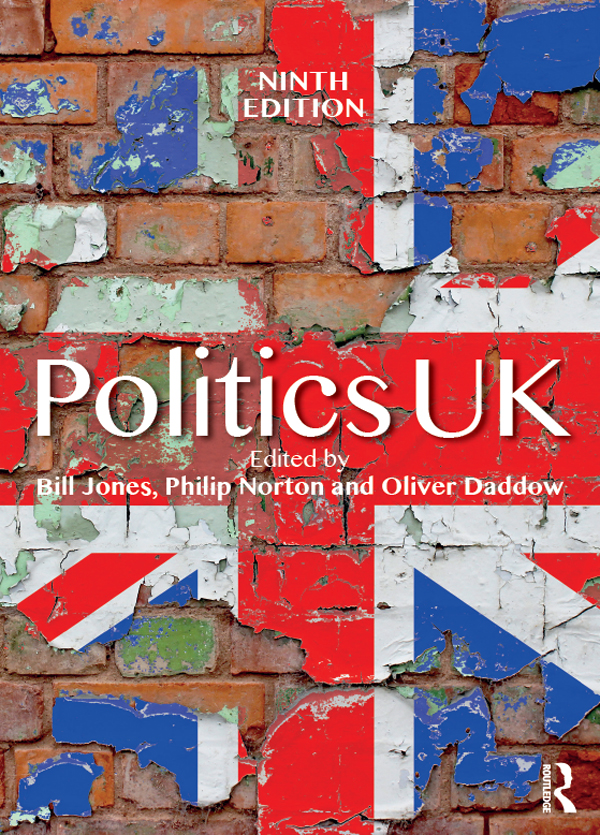
Politics UK This revised and updated ninth edition of the bestselling textbook Politics UK is an indispensable introduction to British politics. It provides a thorough and accessible overview of the institutions and processes of British government, a good grounding in British political history and an incisive introduction to the issues and challenges facing Britain today, including the European referendum and Brexit. The ninth edition welcomes brand new material from seven new contributors to complement the rigorously updated and highly respected chapters retained from the previous edition. It delivers excellent coverage of contemporary events including a new chapter on Euro-scepticism and the European referendum, an assessment of the performance of Labour’s leadership, the trials and tribulations of the Liberal Democrats and UKIP, and the evolving devolution debate in Scotland, led by the Scottish Nationalist Party. Features of the new edition include: Britain in context boxes offering contrasting international perspectives on key themes in British politics A comprehensive ‘who’s who’ of politics in the form of Profile boxes featuring key political figures And another thing . . . pieces containing short articles written by distinguished commentators including Mark Garnett, Sir David Omand, Richard Wilkinson and Sir Simon Jenkins An epilogue analyzing the turbulent state of UK politics following the European referendum With chapters written by highly respected scholars in the field and contemporary articles on real-world politics from well-known political commentators, this textbook is an essential guide for all students of British politics. POLITICAL SCIENCE,General
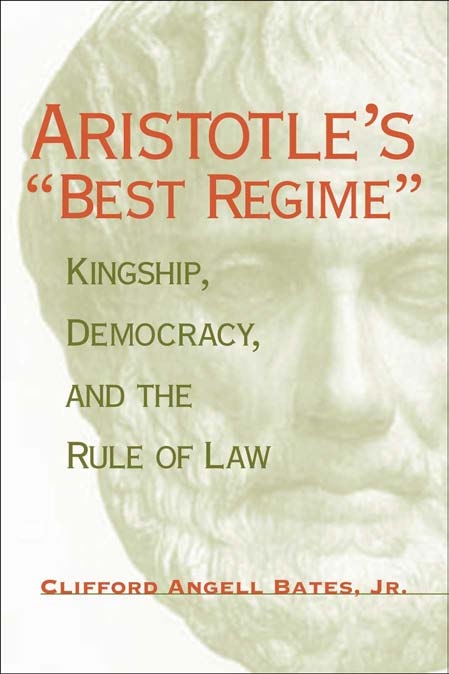
Aristotle's "Best Regime" The collapse of the Soviet Union and other Marxist regimes around the world seems to have left liberal democracy as the only surviving ideology, and yet many scholars of political thought still find liberal democracy objectionable, using Aristotle's Politics to support their views. In this detailed analysis of Book 3 of Aristotle's work, Clifford Angell Bates, Jr., challenges these scholars, demonstrating that Aristotle was actually a defender of democracy.Proving the relevance of classical political philosophy to modern democratic problems, Bates argues that Aristotle not only defends popular rule but suggests that democracy, restrained by the rule of law, is the best form of government. According to Aristotle, because human beings are naturally sociable, democracy is the regime that best helps man reach his potential; and because of human nature, it is inevitable democracies will prevail.Bates explains why Aristotle's is a sound position between two extremes -- participatory democracy, which romanticizes the people, and elite theory, which underrates them. Aristotle, he shows, sees the people as they really are and nevertheless believes their self-rule, under law, is ultimately better than all competing forms. However, the philosopher does not believe democracy should be imposed universally. It must arise out of the given cultural, environmental, and historical traditions of a people or its will fall into tyranny.Bates's fresh interpretation rests on innovative approaches to reading Book 3 -- which he deems vital to understanding all of Aristotle's Politics. Examining the work in the original Greek as well as in translation, he addresses questions about the historical Aristotle versus the posited Aristotle, the genre and structure of the text, and both the theoretical and the dialogic nature of the work. Carting Aristotle's rhetorical strategies, Bates shows that Book 3 is not simply a treatise but a series of dialogues that develop a nuanced defense of democratic rule.Bates's accessible and faithful exposition of Aristotle's work confirms that the philosopher's teachings are not merely of historical interest but speak directly to liberal democracy's current crisis of self-understanding. POLITICAL SCIENCE,General

Understanding Global Security Fully revised to incorporate recent developments, this fourth edition of Understanding Global Security analyses the variety of ways in which people's lives are threatened and/or secured in contemporary global politics. The traditional focus of Security Studies texts: war, deterrence and terrorism, are analysed alongside non-military security issues such as famine, crime, disease, disasters, environmental degradation and human rights abuses to provide a comprehensive survey of how and why people are killed in the contemporary world. This new edition features: Greater coverage of the evolving theoretical literature on security, including more analysis of critical theory perspectives and emerging schools of thought. Reflections on recent developments in the conflicts in Syria and Ukraine. New data and cases on poverty, hunger and depression and greater analysis of the social and political implications of the prolonged period of stagnation the global economy has gone through. New content reflecting the recent resurgence in populist nationalism evident in the election of Trump in the USA, the UK’s exit from the EU and the authoritarian turn taken in many countries. Analysis of the 2015 Paris climate change treaty and the international responses to recent pandemics such as Ebola and Zika A new section has been included on suicide, plugging a gap evident in the earlier editions. User-friendly and easy to follow, this highly acclaimed and popular academic textbook is designed to make a complex subject accessible to all and will continue to be essential reading for everyone interested in security. POLITICAL SCIENCE,General
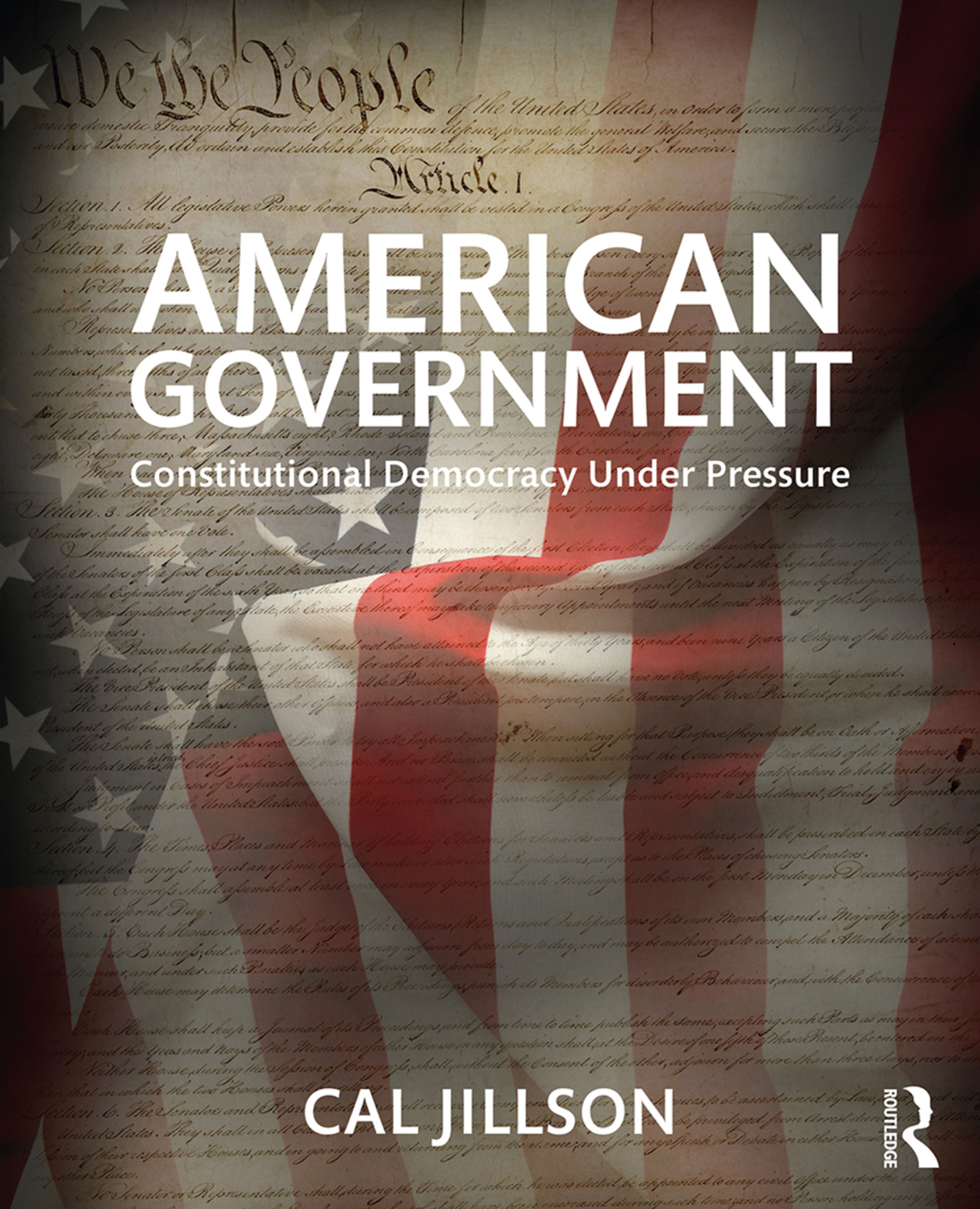
American Government American Government: Constitutional Democracy Under Pressure highlights the necessary tension between our constitutional principles and institutions and the populist heat that sometimes roils our national politics, especially at the current political moment. Our constitutional democracy has been under pressure for some time, but few would deny that fears for its fate have deepened in just the past few years. We assume that our political institutions will limit and contain contemporary populism, just as the Founders intended and as they have in the past, but will they? An increasingly polarized electorate, urging their representatives to fight and never to compromise, may be stressing Constitutional limits. This new, compact core text offers to help American government teachers lead their students to a nuanced theoretical and practical understanding of what is happening in the politics of their Constitutional democracy today. A new, brief edition of Jillson's American Government text that is compact yet comprehensive. The "Constitutional Democracy Under Pressure" theme is timely and provocative. Puts contemporary trends toward polarization and populism in context. POLITICAL SCIENCE,General

Congress in Context The U.S. Congress is by the far the least popular (and most misunderstood) branch of the federal government. Congress in Context de-mystifies the institution, giving students a comprehensive and practical understanding of Congress and the legislative process. This book takes a different approach to the study of Congress than other texts. Usually Congress is treated in isolation from the rest of the government. But the Framers of the Constitution explicitly intended for the branches of government to be interdependent. Congress in Context introduces readers to Congress's critical role in the context of this interdependent system. Using the metaphor of a board of directors, the authors explain the three key roles of Congress within the federal government (authorizing what government does, funding its activities, and supervising how it carries out the laws Congress passes) and shows students how Congress interacts with the rest of the government to exercise these powers. The thoroughly expanded and revised second edition features brand-new chapters on Congress and the courts and Congress and interest groups. It also includes expanded coverage of Congress's relationship with the executive branch, campaign finance, and today's major budget issues. Grounded in the latest political science literature coupled with contemporary examples, Congress in Context offers students an informed yet accessible introduction to how the legislative branch carries out its duties. POLITICAL SCIENCE,General
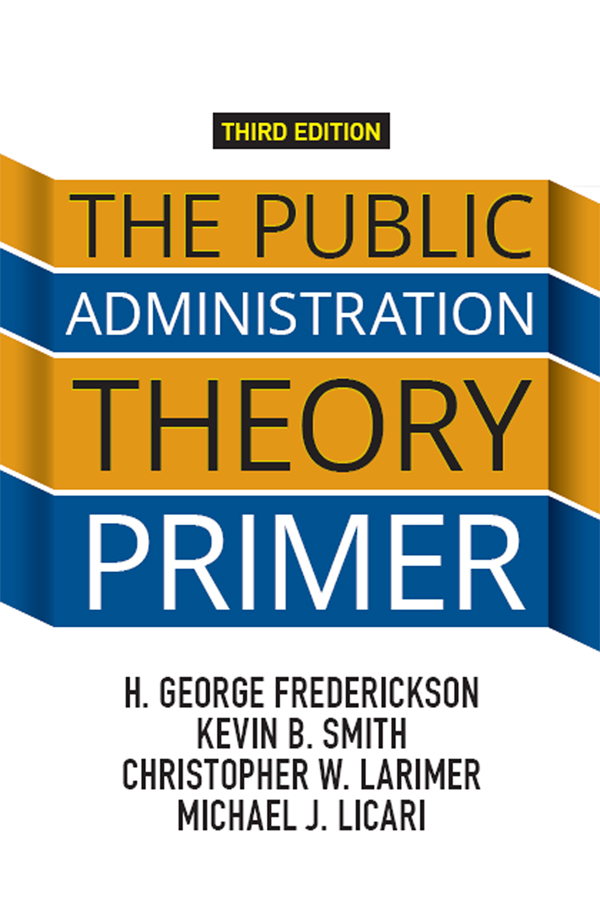
The Public Administration Theory Primer The Public Administration Theory Primer explores how the science and art of public administration is definable, describable, replicable, and cumulative. The authors survey a broad range of theories and analytical approaches—from public institutional theory to theories of governance—and consider which are the most promising, influential, and important for the field. This book paints a full picture of how these theories contribute to, and explain, what we know about public administration today. The third edition is fully revised and updated to reflect the latest developments and research in the field including more coverage of governments and governance, feminist theory, emotional labor theory, and grounded research methodology. Expanded chapter conclusions and a brand-new online supplement with sample comprehensive exam questions and summary tables make this an even more valuable resource for all public administration students. POLITICAL SCIENCE,General

Integrated Peacebuilding Integrated Peacebuilding addresses the importance of weaving peacebuilding methods into diverse sectors including development, humanitarian assistance, gender, business, media, health, and the environment - areas where such work is needed the most. Incorporating peacebuilding approaches in these fields is critical for transforming today's protracted conflicts into tomorrow's sustainable peace. Covering both theory and practice, Dr. Zelizer and his team of leading academics and practitioners present original essays discussing the infrastructure of the peacebuilding field (outlining key actors, donors, and underlying motivations) as well as the ethical dilemmas created by modern conflict. Exploring both the challenges and lessons to be found in this emerging field, Integrated Peacebuilding is perfect for courses on peacebuilding, conflict resolution, international development, and related fields. POLITICAL SCIENCE,General
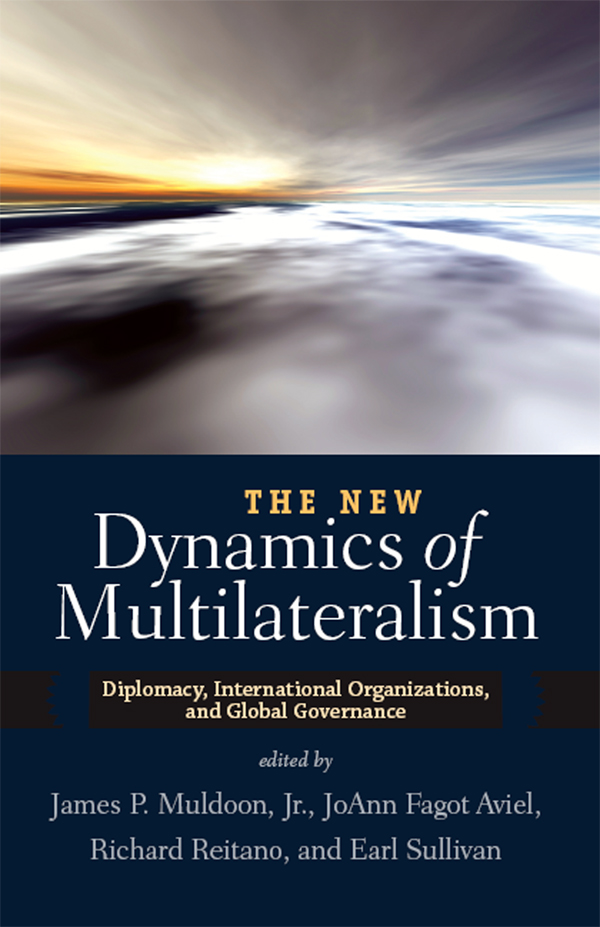
The New Dynamics of Multilateralism This timely new book focuses on the various dynamics of contemporary multilateralism as it relates to global issues, global governance, and global institutions. Invited authorities, including academics, business people, and members of international groups, contribute original essays on how multilateralism as an institution has been affected by globalization, the rise of civil society and global business, emerging economic and political conditions, and new threats to peace and security in the world. Emphasizing practical applications over theoretical foundations, The New Dynamics of Multilateralism helps students understand how the practice of multilateral diplomacy has been influenced by the changes in the processes and procedures of international organizations and the role of multilateralism in the transformation of the international system of governance and the transition to an emerging new global order. POLITICAL SCIENCE,General
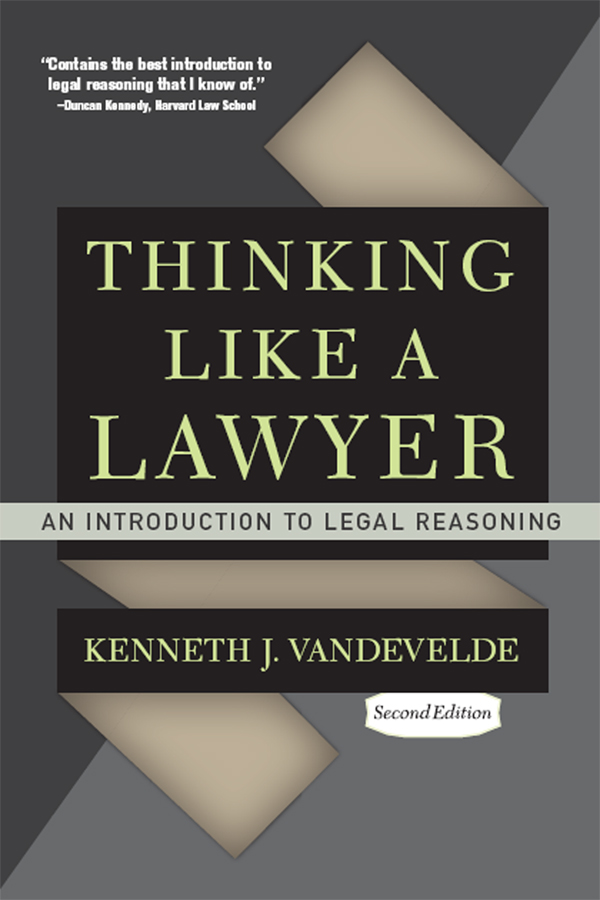
Thinking Like a Lawyer Law students, law professors, and lawyers frequently refer to the process of "thinking like a lawyer," but attempts to analyze in any systematic way what is meant by that phrase are rare. In his classic book, Kenneth J. Vandevelde defines this elusive phrase and identifies the techniques involved in thinking like a lawyer. Unlike most legal writings, which are plagued by difficult, virtually incomprehensible language, this book is accessible and clearly written and will help students, professionals, and general readers gain important insight into this well-developed and valuable way of thinking. Updated for a new generation of lawyers, the second edition features a new chapter on contemporary perspectives on legal reasoning. A useful new appendix serves as a survival guide for current and prospective law students and describes how to apply the techniques in the book to excel in law school. POLITICAL SCIENCE,General

Administrative Law for Public Managers This book focuses on the essentials that public managers should know about administrative law—why we have administrative law, the constitutional constraints on public administration, and administrative law’s frameworks for rulemaking, adjudication, enforcement, transparency, and judicial and legislative review. Rosenbloom views administrative law from the perspectives of administrative practice, rather than lawyering with an emphasis on how various administrative law provisions promote their underlying goal of improving the fit between public administration and U.S. democratic-constitutionalism. Organized around federal administrative law, the book explains the essentials of administrative law clearly and accurately, in non-technical terms, and with sufficient depth to provide readers with a sophisticated, lasting understanding of the subject matter. POLITICAL SCIENCE,General
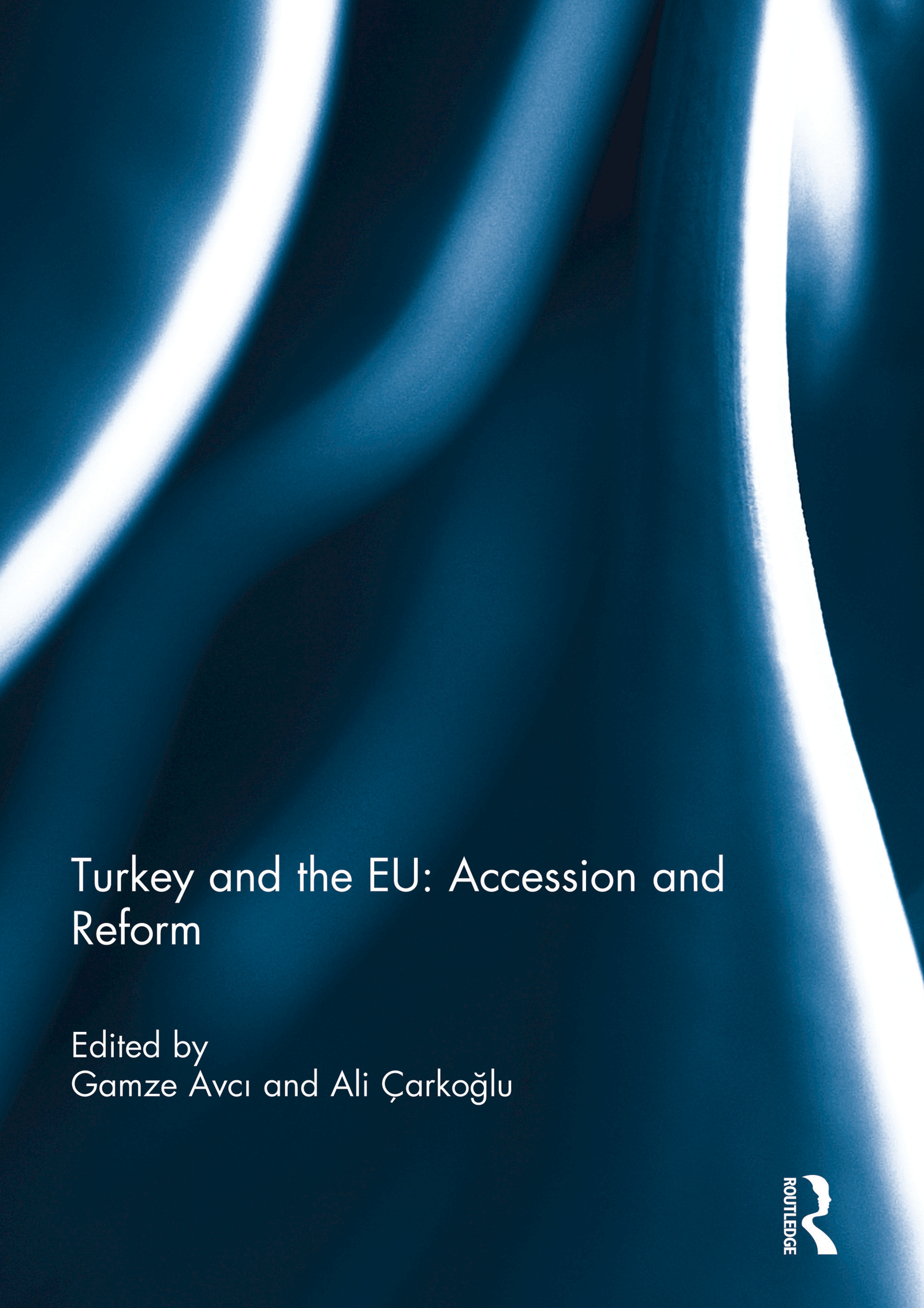
Turkey and the EU Turkish accession to the European Union is an important but controversial item on the agenda of the European Union. By focusing on the various domestic sources that drive Turkish politics, this comprehensive study of both classic and new topics supported by fresh, new insights fills a void in the current literature on Turkey-EU relations. This volume is a comprehensive, state of the art study of domestic politics and policies and their role in Turkey’s EU accession. Contributions are obtained from established scholars, acknowledged for their expertise in their respective fields. The content is structured along issues, dynamics, actors and policies that drive Turkish politics and it provides an integrated assessment of the dynamics in Turkey-EU relations to general readers, students and specialists in EU Enlargement and Turkish politics alike. Original contributions to ‘classic’ topics such as the customs union, human rights, military, civil society, public and elite opinion, political parties and the Kurdish issue are made by assessing the domestic sources of recent developments during the negotiations period. In addition, ‘new’ topics are included that previously have not been covered or analyzed in volumes on Turkish-EU relations such as the Alevi issue, European Turks, corruption in Turkey, and Turkish parliamentary elite opinion on Turkey and the EU. This book was published as a special issue of South European Society and Politics. POLITICAL SCIENCE,General
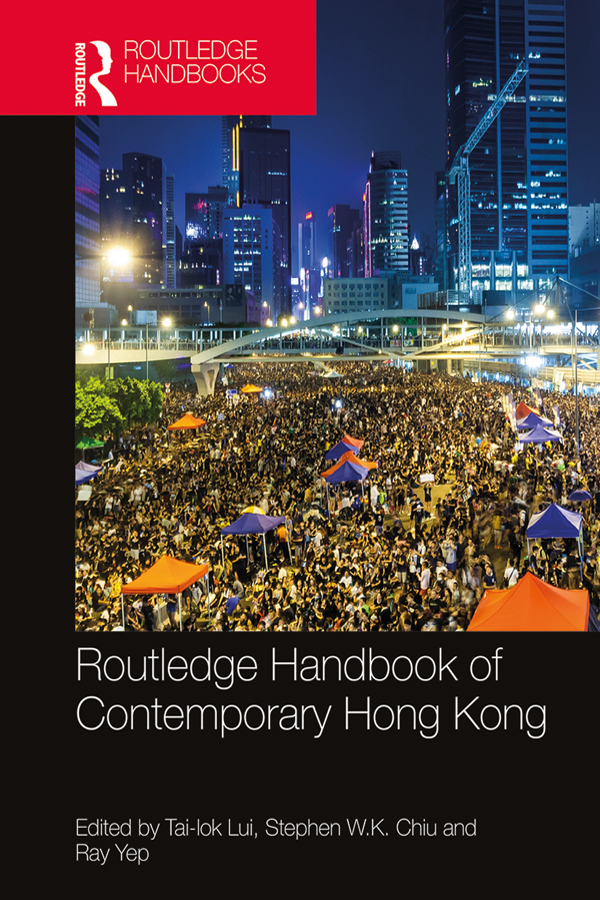
Routledge Handbook of Contemporary Hong Kong When Britain and China negotiated the future of Hong Kong in the early 1980s, their primary concern was about maintaining the status quo. The rise of China in the last thirty years, however, has reshaped the Beijing-Hong Kong dynamic as new tensions and divisions have emerged. Thus, post-1997 Hong Kong is a case about a global city’s democratic transition within an authoritarian state. The Routledge Handbook of Contemporary Hong Kong introduces readers to these key social, economic, and political developments. Bringing together the work of leading researchers in the field, it focuses on the process of transition from a British colony to a Special Administrative Region under China’s sovereign rule. Organized thematically, the sections covered include: ‘One Country, Two Systems’ in practice Governance in post-colonial Hong Kong Social mobilization The changing social fabric of Hong Kong society Socio-economic development and regional integration The future of Hong Kong. This book provides a thorough introduction to Hong Kong today. As such, it will be invaluable to students and scholars of Hong Kong’s politics, culture and society. It will also be of interest to those studying Chinese political development and the impact of China’s rise more generally. POLITICAL SCIENCE,General
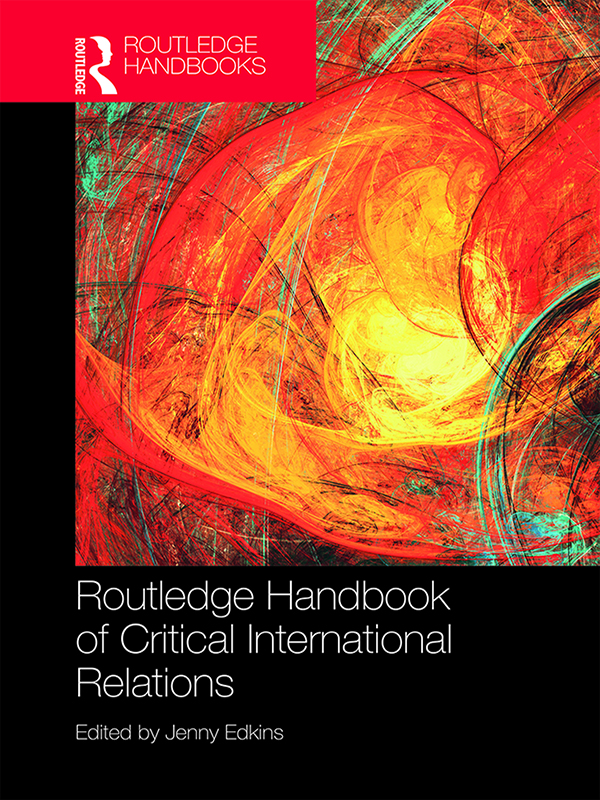
Routledge Handbook of Critical International Relations Critical international relations is both firmly established and rapidly expanding, and this Handbook offers a wide-ranging survey of contemporary research. It affords insights into exciting developments, more challenging issues and less prominent topics, examining debates around questions of imperialism, race, gender, ethics and aesthetics, and offering both an overview of the existing state of critical international politics and an agenda-setting collection that highlights emerging areas and fosters future research. Sections cover: critique and the discipline; relations beyond humanity; art and narrative; war, religion and security; otherness and diplomacy; spaces and times; resistance; and embodiment and intimacy. An international group of expert scholars, whose contributions are commissioned for the volume, provide chapters that facilitate teaching at advanced undergraduate and postgraduate level, inspire new generations of researchers in the field and promote collaboration, cross-fertilisation and inspiration across sub-fields often treated separately, such as feminism, postcolonialism and poststructuralism. The volume sees these strands as complementary not contradictory, and emphasises their shared political goals, shared theoretical resources and complementary empirical practices. Each chapter offers specific, focused, in-depth analysis that complements and exemplifies the broader coverage, making this Routledge Handbook of Critical International Relations essential reading for all students and scholars of international relations. POLITICAL SCIENCE,General
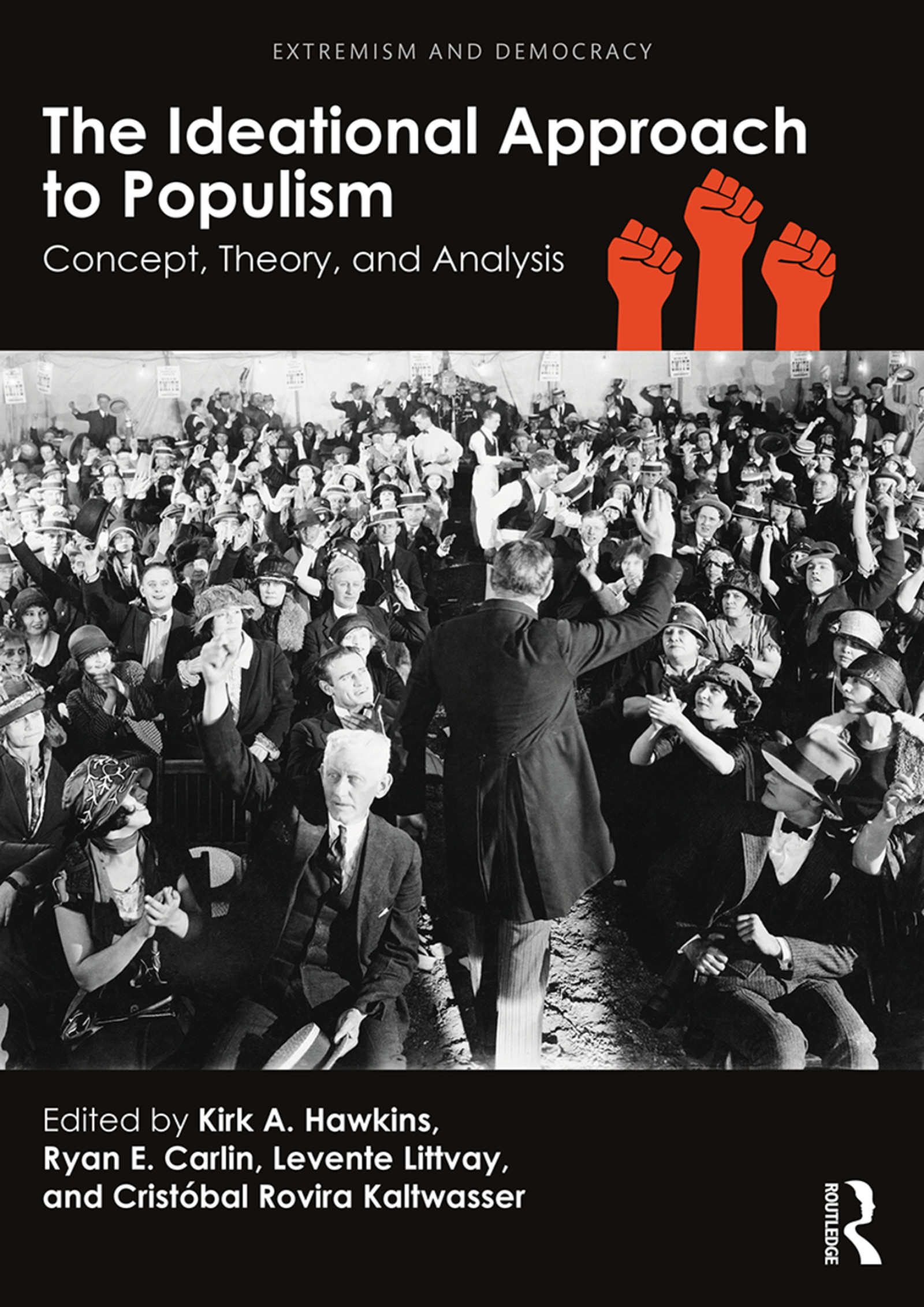
The Ideational Approach to Populism Populism is on the rise in Europe and the Americas. Scholars increasingly understand populist forces in terms of their ideas or discourse, one that envisions a cosmic struggle between the will of the common people and a conspiring elite. In this volume, we advance populism scholarship by proposing a causal theory and methodological guidelines – a research program – based on this ideational approach. This program argues that populism exists as a set of widespread attitudes among ordinary citizens, and that these attitudes lie dormant until activated by weak democratic governance and policy failure. It offers methodological guidelines for scholars seeking to measure populist ideas and test their effects. And, to ground the program empirically, it tests this theory at multiple levels of analysis using original data on populist discourse across European and US party systems; case studies of populist forces in Europe, Latin America, and the US; survey data from Europe and Latin America; and experiments in Chile, the US, and the UK. The result is a truly systematic, comparative approach that helps answer questions about the causes and effects of populism. POLITICAL SCIENCE,General
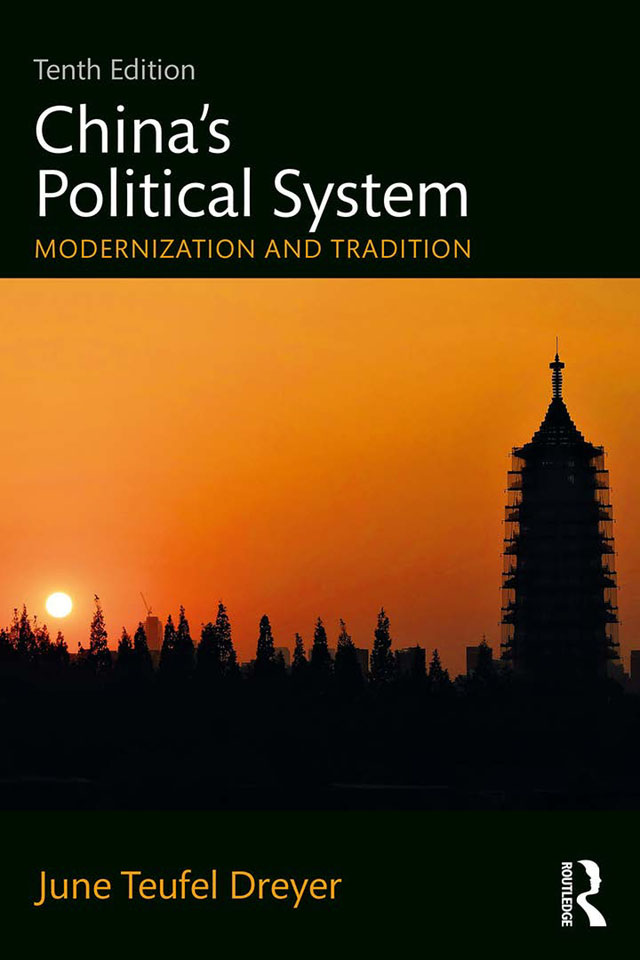
China’s Political System China’s Political System provides a concise introduction to the political, economic, and social factors that determine China's government. Highly respected specialist June Teufel Dreyer offers expert analysis of the challenges facing China's economic, legal, military, social, and cultural institutions while examining the historical context and current trends. China's Political System asks readers to think about the broader problem of governance and mordernization in China and their global implications by comprehensively showing how the past and present impact leaders, citizens, ethnic minorities, and policies. New to the Tenth Edition: the first text to incorporate results from the Nineteenth Party Congress and Thirteenth National People's Congress. includes a new chapter on developments under Xi Jinping considers the effects of slowing economic growth on politics and society addresses recent Chinese assertiveness in military and foreign policy The tenth edition of China’s Political System continues to provide all of the tools professors need to introduce their students to Chinese politics in ways that are informed, accessible, and intriguing. POLITICAL SCIENCE,General
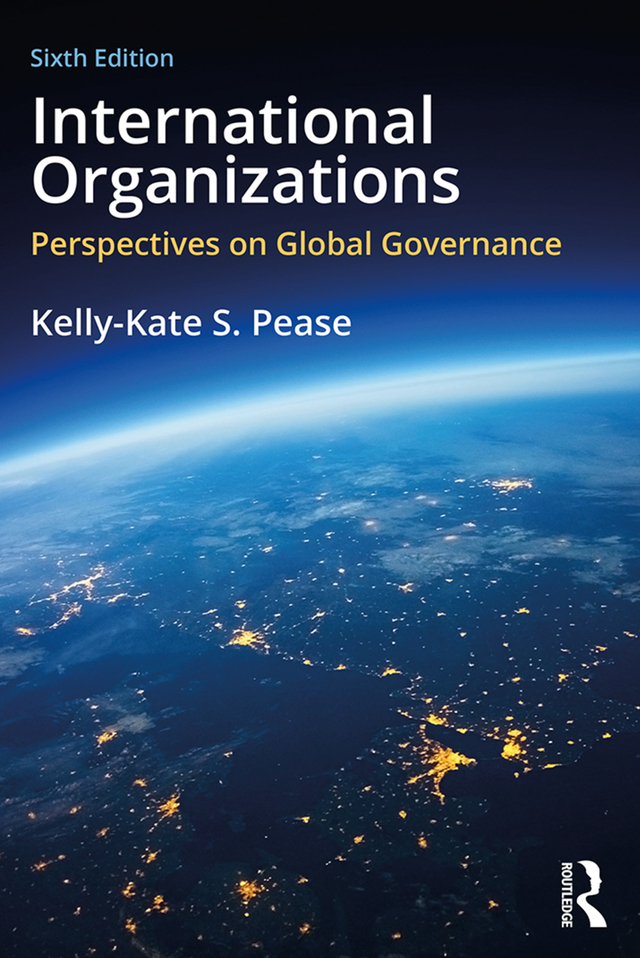
International Organizations Drawing on mainstream and critical theoretical approaches, International Organizations offers a comprehensive examination of international organizations’ political and structural role in world politics. This text details the types and activities of international organizations and provides students with the conceptual tools needed to evaluate their effectiveness. Surveying key issue areas from international and human security to trade and the environment, International Organizations looks at present and future possibilities for global governance from a broad range of perspectives. New to the Sixth Edition Focused on the seismic shifts caused by the rise of national populism and the effects on the more liberal institutions of global governance. Fully revised throughout with a feature on the EU in the face of Brexit, the Greek financial crisis, and global migration. Adds a new section on the Arab League, expanded coverage of NGOs, and updates on the Paris Climate Accords. Overhauls the chapter on International Security including expanded coverage of the UN’s present and historical role. Includes a new chapter on Regional Security covering NATO and ECOWAS. Provides new case studies on Syria, Ukraine, SDGs, and the global migration crisis, among several others. POLITICAL SCIENCE,General
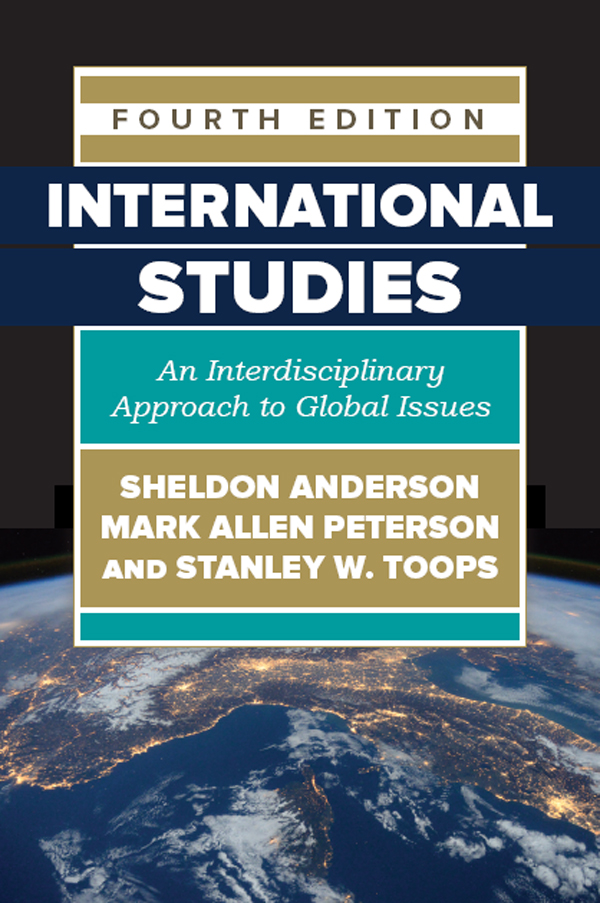
International Studies This core text is the first to provide a much-needed interdisciplinary approach to international studies. Emphasizing the interconnected nature of history, geography, anthropology, economics, and political science, International Studies details the methodologies and subject matter of each discipline then applies these discipline lenses to seven regions: Europe; East Asia and the Pacific; South and Central Asia; sub-Saharan Africa; the Middle East and North Africa; Latin America; and North America. This disciplinary and regional combination provides an indispensable, cohesive framework for understanding global issues. The fully updated fourth edition includes four new global issues chapters: The Refugee Crisis in Europe; The Syrian Civil War and the Rise of the Islamic State; Global Climate Change; and The Globalization of Modern Sports.. POLITICAL SCIENCE,General
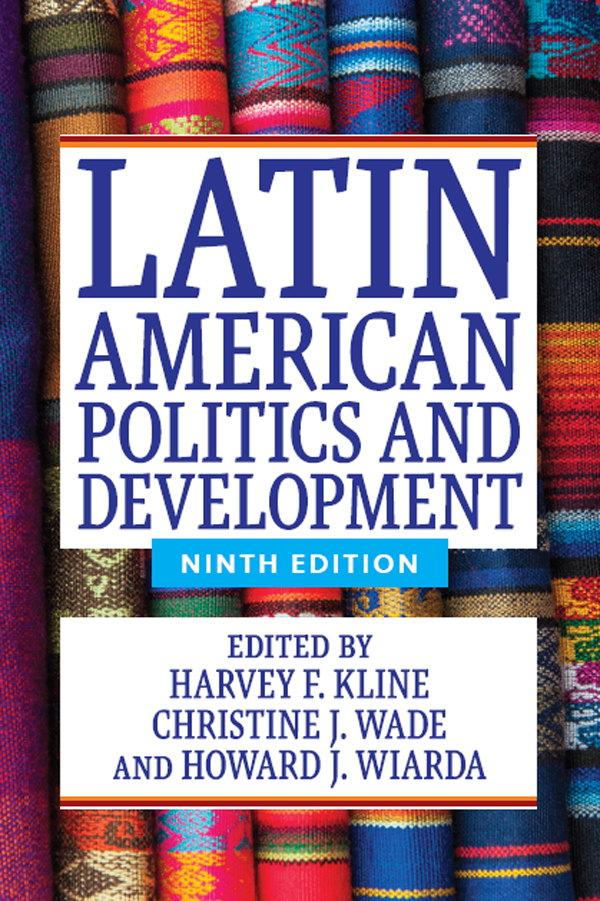
Latin American Politics and Development For over thirty years, Latin American Politics and Development has kept instructors and students abreast of current affairs and changes in Latin America. Now in its ninth edition, this definitive text has been updated throughout and features contributions from experts in the field, including twenty new and revised chapters on Mexico, Central America,the Caribbean, and South America. POLITICAL SCIENCE,General
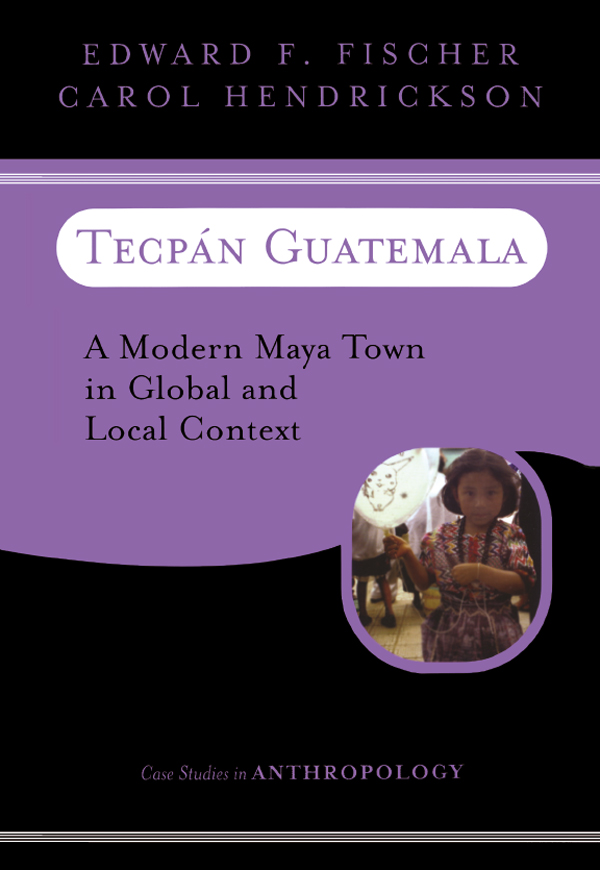
Tecpan Guatemala This book discusses the indigenous people of Tecpan Guatemala, a predominantly Kaqchikel Maya town in the Guatemalan highlands. It seeks to build on the traditional strengths of ethnography while rejecting overly romantic and isolationist tendencies in the genre. POLITICAL SCIENCE,General

Shirley Chisholm A staunch proponent of breaking down racial and gender barriers, Shirley Chisholm had the esteemed privilege of being a pioneer in many aspects of her life. She was the first African American woman from Brooklyn elected to the New York State legislature and the first African American woman elected to Congress in 1968. She also made a run for the Democratic Party nomination for president in 1972. Focusing on Chisholm's lifelong advocacy for fair treatment, access to education, and equal pay for all American minority groups, this book explores the life of a remarkable woman in the context of twentieth-century urban America and the tremendous social upheaval that occurred after World War II. About the Lives of American Women series: Selected and edited by renowned women's historian Carol Berkin, these brief biographies are designed for use in undergraduate courses. Rather than a comprehensive approach, each biography focuses instead on a particular aspect of a woman's life that is emblematic of her time, or which made her a pivotal figure in the era. The emphasis is on a 'good read', featuring accessible writing and compelling narratives, without sacrificing sound scholarship and academic integrity. Primary sources at the end of each biography reveal the subject's perspective in her own words. Study questions and an annotated bibliography support the student reader. POLITICAL SCIENCE,General

In Defense of Public Lands Debates continue to rage over the merits or flaws of public land and whether or not it should be privatized—or at least, radically reconfigured in some way. In Defense of Public Lands offers a comprehensive refutation of the market-oriented arguments. Steven Davis passionately advocates that public land ought to remain firmly in the public’s hands. He reviews empirical data and theoretical arguments from biological, economic, and political perspectives in order to build a case for why our public lands are an invaluable and irreplaceable asset for the American people. In Defense of Public Lands briefly lays out the history and characteristics of public lands at the local, state, and federal levels while examining the numerous policy prescriptions for their privatization or, in the case of federal lands, transfer. He considers the dimensions of environmental health; markets and valuation of public land, the tensions between collective values and individual preferences, the nature and performance of bureaucratic management, and the legitimacy of interest groups and community decision-making. Offering a fair, good faith overview of the privatizers’ best arguments before refuting them, this timely book contemplates both the immediate and long-term future of our public lands. POLITICAL SCIENCE,General

The Routledge Handbook of the Politics of Brexit The surprise decision expressed by the British people in the referendum held in June 2016 to leave the European Union was remarkable. It also presents a "natural experiment" where the exposure of a society to an extraordinary event allows scholars to observe, in real time in the real world, the interaction of variables. The Routledge Handbook of the Politics of Brexit takes stock of what we know in the social science community about the Brexit phenomenon so far and looks to make sense of this remarkable process as it unfolds. The book asks simple questions across a range of areas and topics so as to frame the debate into a number of navigable "subdiscussions", providing structure and form to what is an evolving and potentially inchoate topic. As such, it provides a systematic account of the background for, the content of, and the possible implications of Brexit. The handbook therefore does not examine in detail the minutiae of Brexit as it unfolds on a day-to-day basis but raises its sights to consider both the broad contextual factors that shape and are shaped by Brexit and the deeper sources and implications of the British exit from the European Union. Importantly, as interest in Brexit reaches far beyond the shores of the United Kingdom, so an international team of contributors examines and reveals the global implications and the external face of Brexit. The Routledge Handbook of the Politics of Brexit will be essential reading and an authoritative reference for scholars, students, researchers and practitioners involved in and actively concerned about research on Brexit, British politics, European Union politics, and comparative politics and international relations. POLITICAL SCIENCE,General
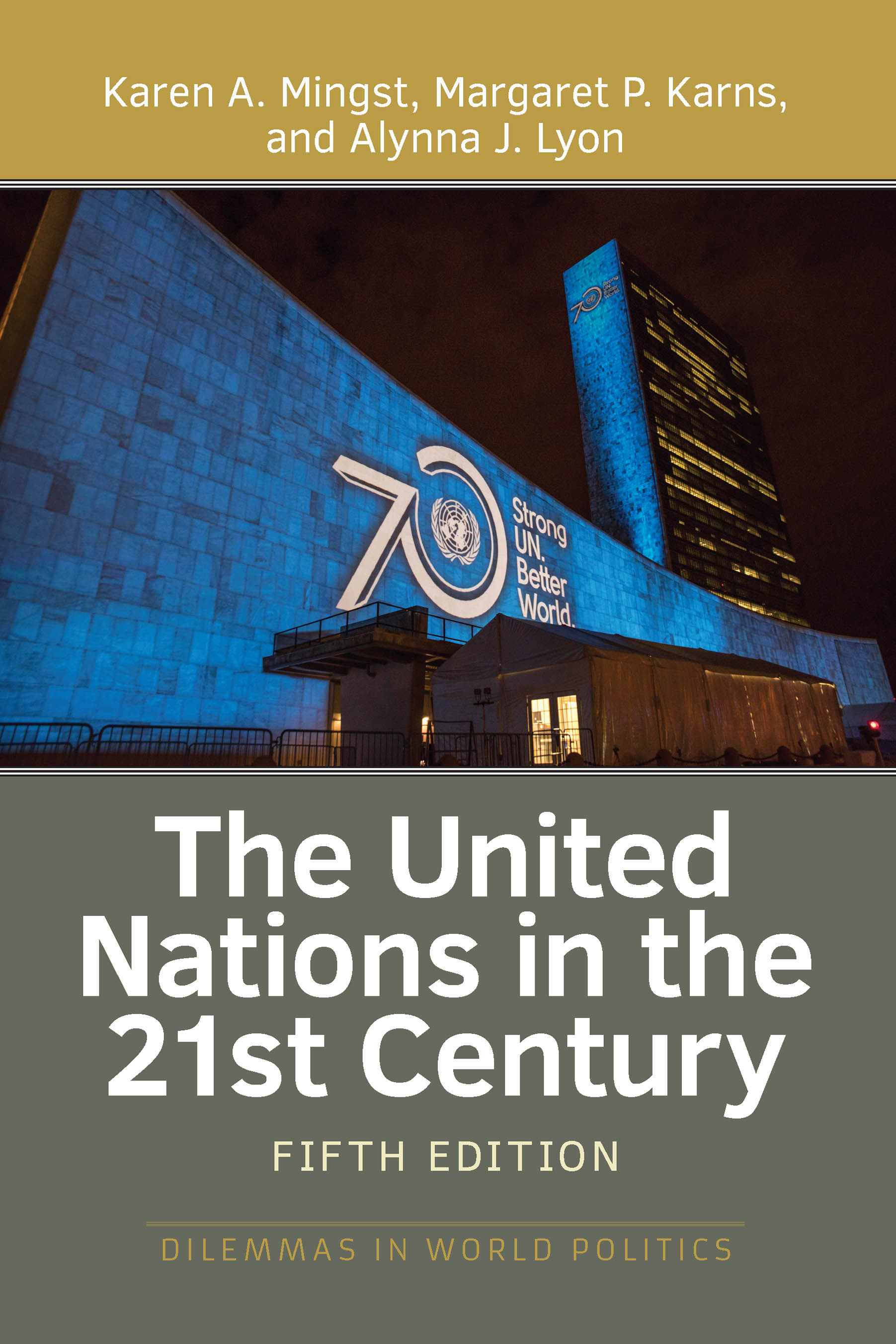
The United Nations in the 21st Century The United Nations in the 21st Century provides a comprehensive yet accessible introduction to the United Nations, exploring the historical, institutional, and theoretical foundations of the UN. This popular text for courses on international organizations and international relations also discusses the political complexities facing the organization today. Thoroughly revised throughout, the fifth edition focuses on major trends since 2012, including changing power dynamics, increasing threats to peace and security, and the growing challenges of climate change and sustainability. It examines the proliferating public-private partnerships involving the UN and the debates over reforming the Security Council and the Secretary-General selection process. This edition also includes new case studies on peacekeeping and the use of force in the Democratic Republic of Congo and Mali, transnational terrorism and the emergence of ISIS, the Security Council's failure to act in Syria, the Syrian and global refugee/migrant crisis, and the conclusion of the Millennium Development Goals and framing of the Sustainable Development Goals. POLITICAL SCIENCE,General
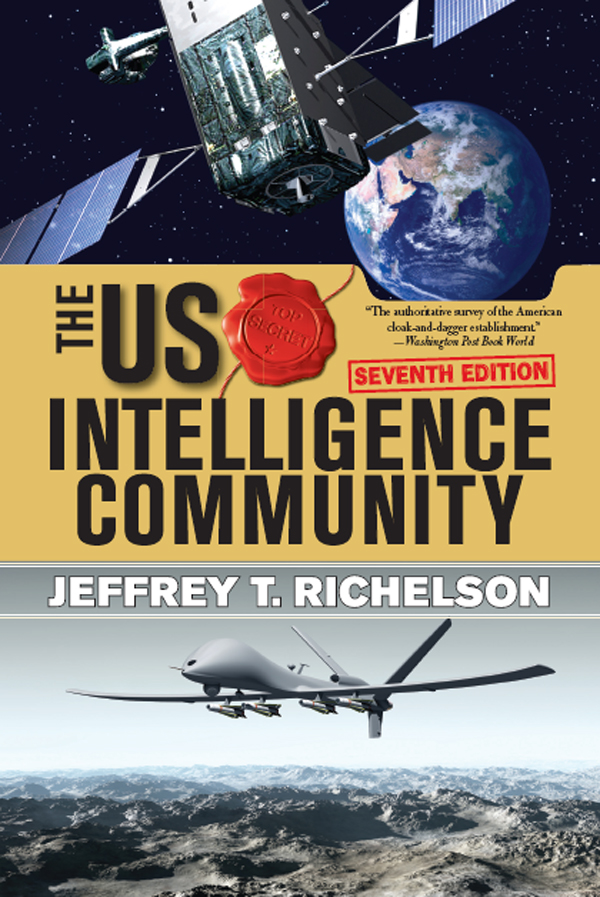
The U.S. Intelligence Community The role of intelligence in US government operations has changed dramatically and is now more critical than ever to domestic security and foreign policy. This authoritative and highly researched book written by Jeffrey T. Richelson provides a detailed overview of America's vast intelligence empire, from its organizations and operations to its management structure. Drawing from a multitude of sources, including hundreds of official documents, The US Intelligence Community allows students to understand the full scope of intelligence organizations and activities, and gives valuable support to policymakers and military operations. The seventh edition has been fully revised to include a new chapter on the major issues confronting the intelligence community, including secrecy and leaks, domestic spying, and congressional oversight, as well as revamped chapters on signals intelligence and cyber collection, geospatial intelligence, and open sources. The inclusion of more maps, tables and photos, as well as electronic briefing books on the book's Web site, makes The US Intelligence Community an even more valuable and engaging resource for students. POLITICAL SCIENCE,General
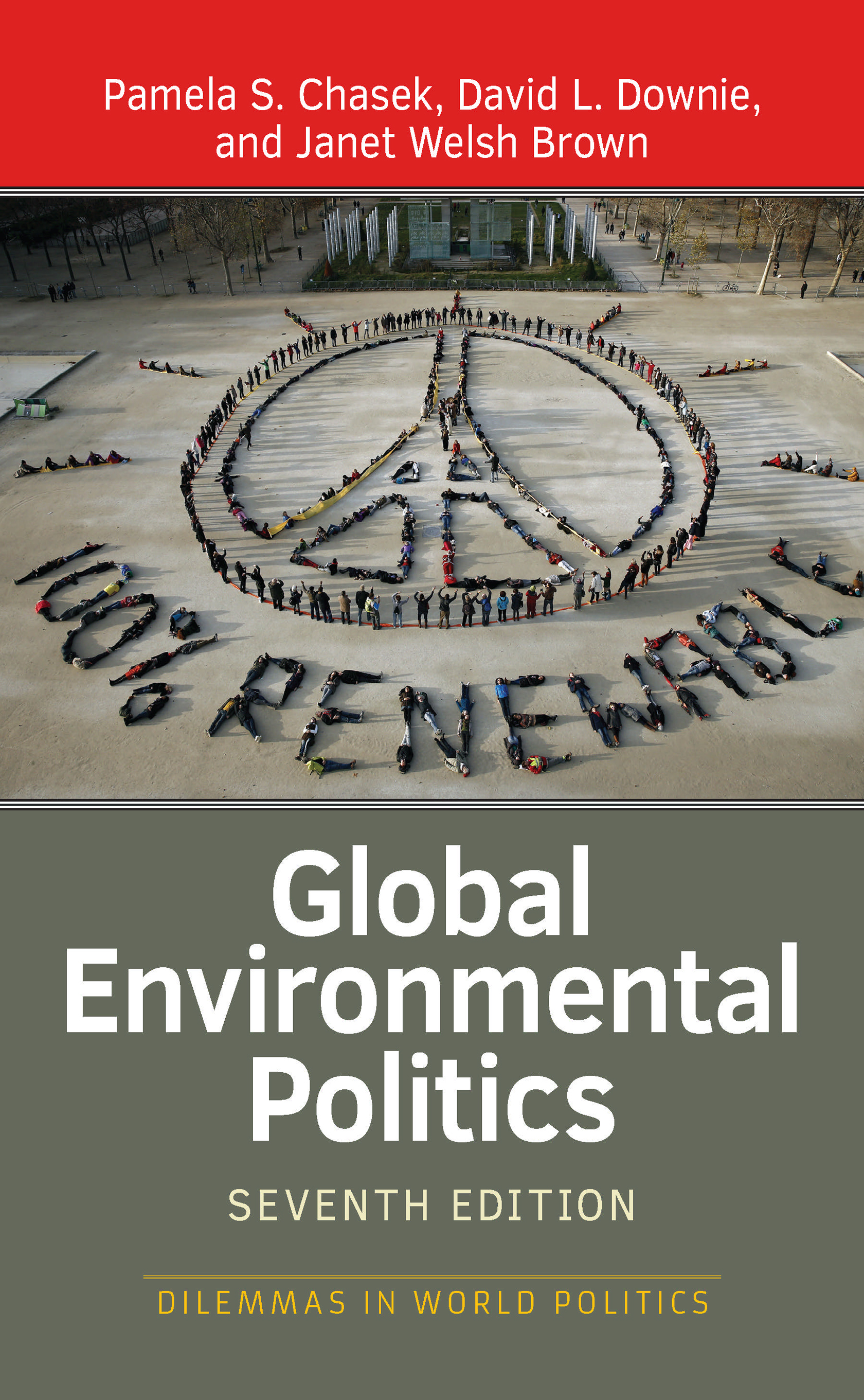
Global Environmental Politics For more than twenty years, Global Environmental Politics has provided an up-to-date, accurate, and unbiased introduction to the world's most pressing environmental issues. This new edition continues this tradition while covering critical new developments in the field. Through case studies on key issues such as climate change, toxic chemicals, and biodiversity loss, the authors detail the development of major environmental regimes. With new material on the adoption of global Sustainable Development Goals and the 2030 Agenda for Sustainable Development; the December 2015 Paris Climate Change conference; and recent meetings of major conventions on desertification, biological diversity, and more; the authors present a comprehensive overview of contemporary international environmental politics. Global Environmental Politics is vital reading for any student wishing to understand the current state of the field and to make informed decisions about which policies might best safeguard our environment for the future. POLITICAL SCIENCE,General
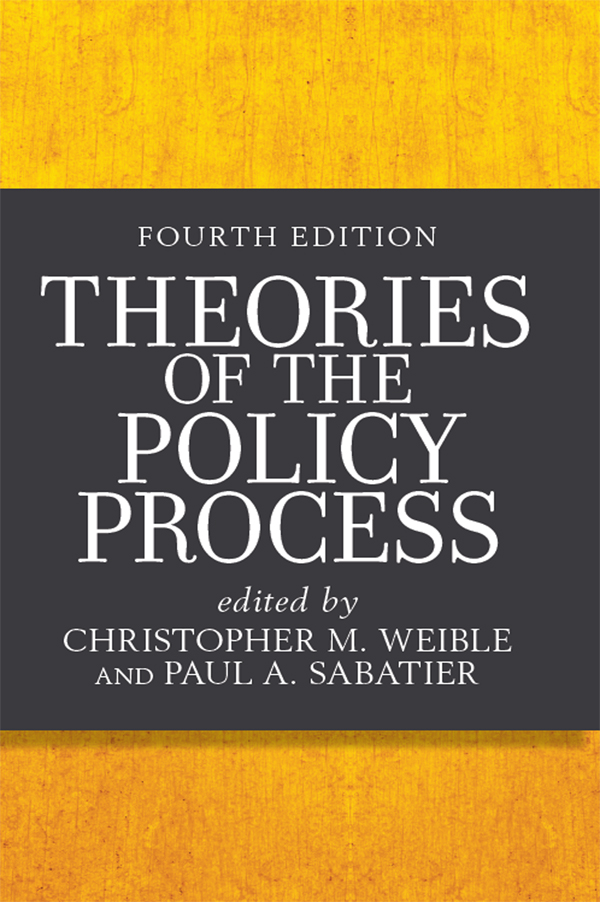
Theories of the Policy Process Theories of the Policy Process provides a forum for the experts in the most established and widely used theoretical frameworks in policy process research to present the basic propositions, empirical evidence, latest updates, and the promising future research opportunities of each framework. This well-regarded volume covers such enduring classics as Multiple Streams (Zahariadis et al.), Punctuated Equilibrium (Jones et al.), Advocacy Coalition Framework (Jenkins-Smith et al.), Institutional Analysis and Development Framework (Schlager and Cox), and Policy Diffusion (Berry and Berry), as well as two newer theories—Policy Feedback (Mettler and SoRelle) and Narrative Policy Framework (McBeth et al.). The fourth edition now includes a discussion of global and comparative perspectives in each theoretical chapter and a brand-new chapter that explores how these theories have been adapted for, and employed in, non-American and non-Western contexts. An expanded introduction and revised conclusion fully examines and contextualizes the history, trajectories and functions of public policy research. Since its first publication in 1999, Theories of the Policy Process has been, and remains, the quintessential gateway to the field of policy process research for students, scholars and practitioners. POLITICAL SCIENCE,General
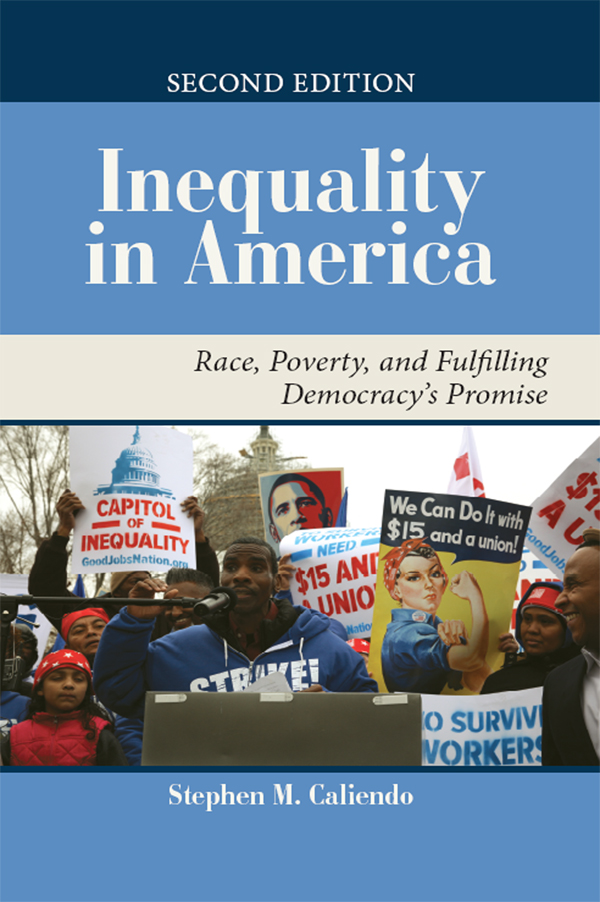
Inequality in America Why does inequality have such a hold on American society and public policy? And what can we, as citizens, do about it? Inequality in America takes an in-depth look at race, class and gender-based inequality, across a wide range of issues from housing and education to crime, employment and health. Caliendo explores how individual attitudes can affect public opinion and lawmakers' policy solutions. He also illustrates how these policies result in systemic barriers to advancement that often then contribute to individual perceptions. This cycle of disadvantage and advantage can be difficult-though not impossible-to break. "Representing" and "What Can I Do?" feature boxes throughout the book highlight key public figures who have worked to combat inequality and encourage students to take action to do the same. The second edition has been thoroughly revised to include the most current data and to cover recent issues and events like the 2016 elections and the Black Lives Matter movement. It now also includes a brand-new chapter on crime and criminal justice and an expanded discussion of immigration. Concise and accessible, Inequality in America paves the way for students to think critically about the attitudes, behaviors and structures of inequality. POLITICAL SCIENCE,General
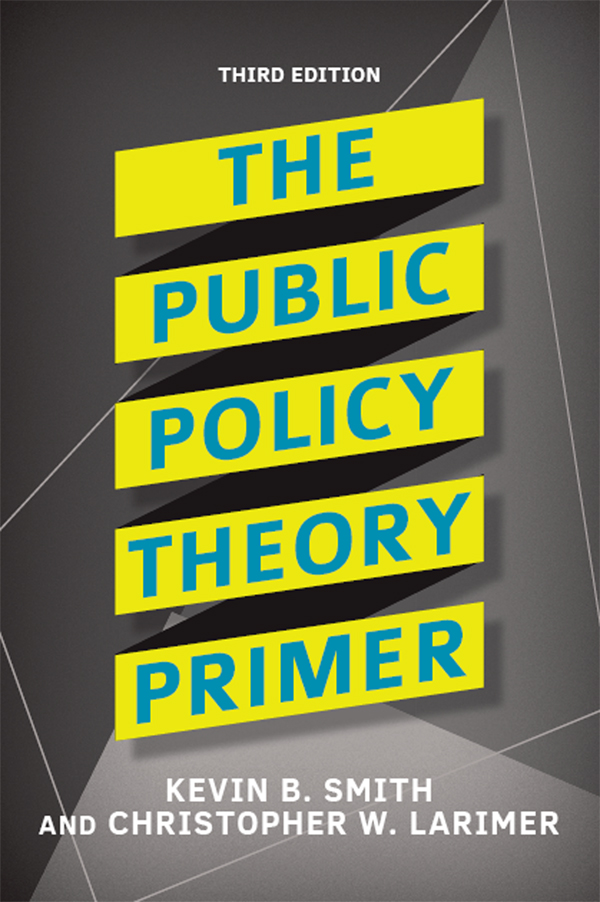
The Public Policy Theory Primer Public policy is a broad and interdisciplinary area of study and research in the field tends to reflect this. Yet for those teaching and studying public policy, the disjointed nature of the field can be confusing and cumbersome. This text provides a consistent and coherent framework for uniting the field of public policy. Authors Kevin B. Smith and Christopher W. Larimer offer an organized and comprehensive overview of the core questions and concepts, major theoretical frameworks, primary methodological approaches, and key controversies and debates in each subfield of policy studies from the policy process and policy analysis to program evaluation and policy implementation. The third edition has been updated throughout to include the latest scholarship and approaches in the field, including new and expanded coverage of behavioral economics, the narrative policy framework, Fourth Generation implementation studies, the policy regime approach, field experiments, and the debate of program versus policy implementation studies. Now with an appendix of sample comprehensive exam questions, The Public Policy Theory Primer remains an indispensable text for the systematic study of public policy. POLITICAL SCIENCE,General

Understanding Conflict Resolution A comprehensive introduction to the study of peace and conflict studies. It explores both the historical roots of the study of conflict management, as well as the contemporary settings and the tools available to states, regional and global organizations where these core ideas apply. POLITICAL SCIENCE,General
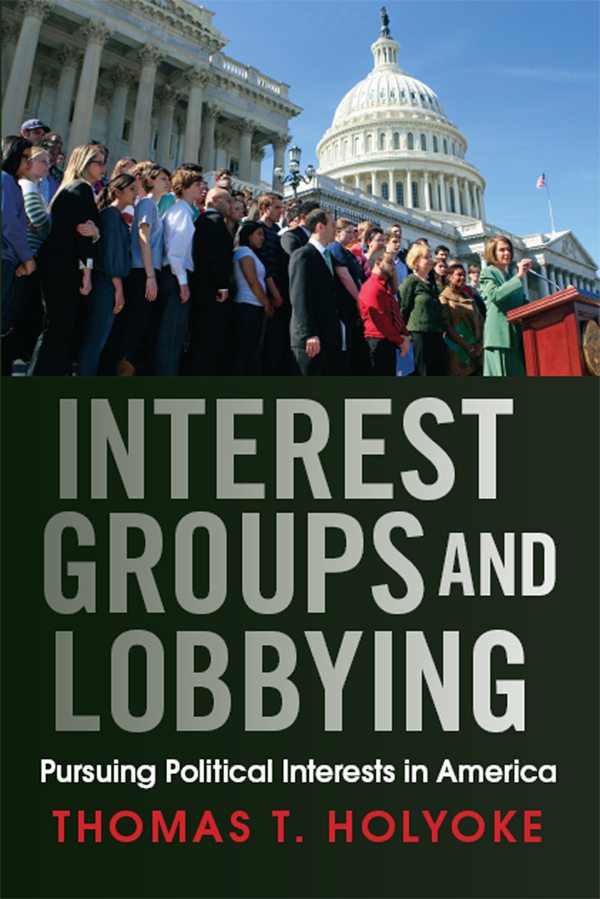
Interest Groups and Lobbying Interest groups and lobbyists play a crucial role in how public policy is made in the United States' representative democracy. By helping citizens organize and pursue their self-interests in the political arena, interest groups and lobbyists are an alternative but very effective form of representation. However, the adversarial nature of interest groups often fuels voter discomfort with the political process. Interest Groups and Lobbying is an accessible and comprehensive text that examines the crux of this conflict. Pulling together two areas of interest group research (why advocacy organizations form and how they are able to gain influence in Washington) DC. Thomas T. Holyoke shows students the inner workings of interest groups in the United States. Using case studies to clarify and expand on the issues surrounding lobbying and group action in federal, state, and local government, Holyoke explores how we can use interest groups and their adversarial impulse to achieve the greatest good for the greatest number of people. POLITICAL SCIENCE,General

Public Opinion Public Opinion is a comprehensive and multidisciplinary examination of public opinion in the United States. Drawing on scholarship in political science, psychology, sociology, and communications, the authors explore the nature of political and social attitudes in the United States and how these attitudes are shaped by various institutions, with an emphasis on mass media. The book also serves as a provocative starting point for the discussion of citizen moods, political participation, and voting behavior. Feature boxes and illustrations throughout help students understand all aspects of the elusive phenomenon we call public opinion. The third edition has been thoroughly revised and updated to reflect how public opinion is studied today, and to incorporate current data and debates. The book now contains two revised and reframed theory chapters 'Group Membership and Public Opinion' and 'Public Opinion and Social Process', as well as new coverage of the influence of online and social media on public opinion, especially in issue opinions and campaigns. POLITICAL SCIENCE,General
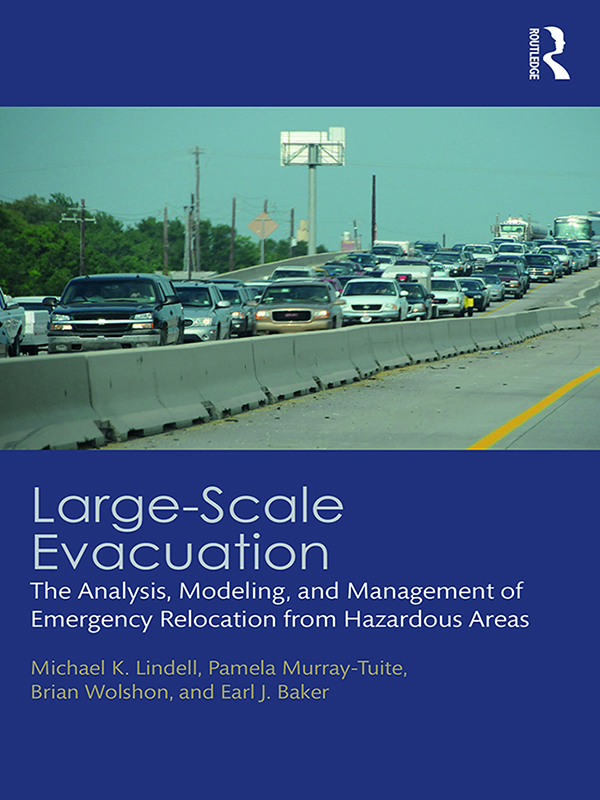
Large-Scale Evacuation Large-Scale Evacuation introduces the reader to the steps involved in evacuation modelling for towns and cities, from understanding the hazards that can require large-scale evacuations, through understanding how local officials decide to issue evacuation advisories and households decide whether to comply, to transportation simulation and traffic management strategies. The author team has been recognized internationally for their research and consulting experience in the field of evacuations. Collectively, they have 125 years of experience in evacuation, including more than 140 projects for federal and state agencies. The text explains how to model evacuations that use the road transportation network by combining perspectives from social scientists and transportation engineers, fields that have commonly approached evacuation modelling from distinctly different perspectives. In doing so, it offers a step-by-step guide through the key questions needed to model an evacuation and its impacts to the evacuation route system as well as evacuation management strategies for influencing demand and expanding capacity. The authors also demonstrate how to simulate the resulting traffic and evacuation management strategies that can be used to facilitate evacuee movement and reduce unnecessary demand. Case studies, which identify key points to analyze in an evacuation plan, discuss evacuation termination and re-entry, and highlight challenges that someone developing an evacuation plan or model should expect, are also included. This textbook will be of interest to researchers, practitioners, and advanced students. POLITICAL SCIENCE,General
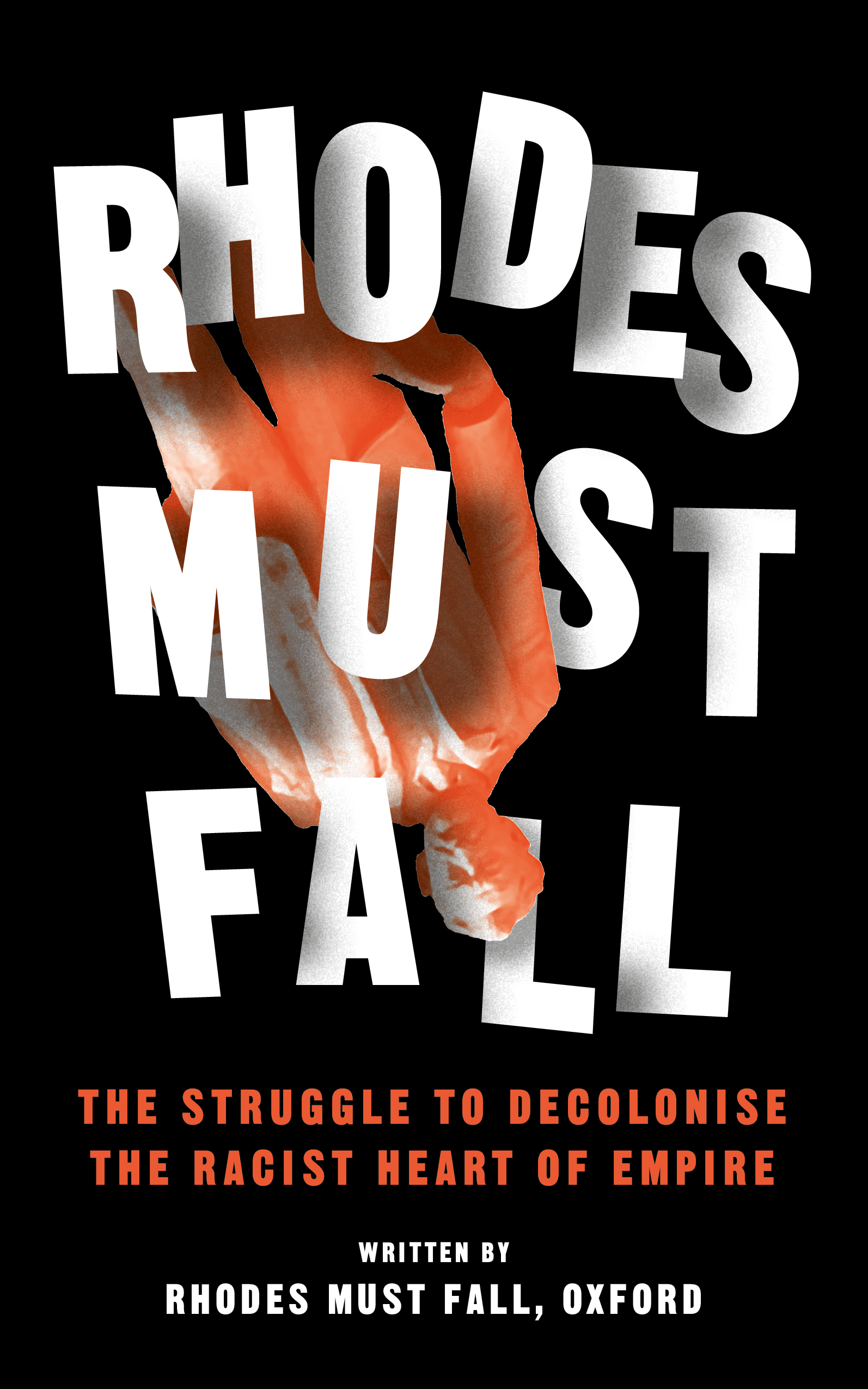
Rhodes Must Fall A decisive book written by the Rhodes Must Fall movement, offering unparalleled insight into the institutional racism at the heart of empire. POLITICAL SCIENCE,General
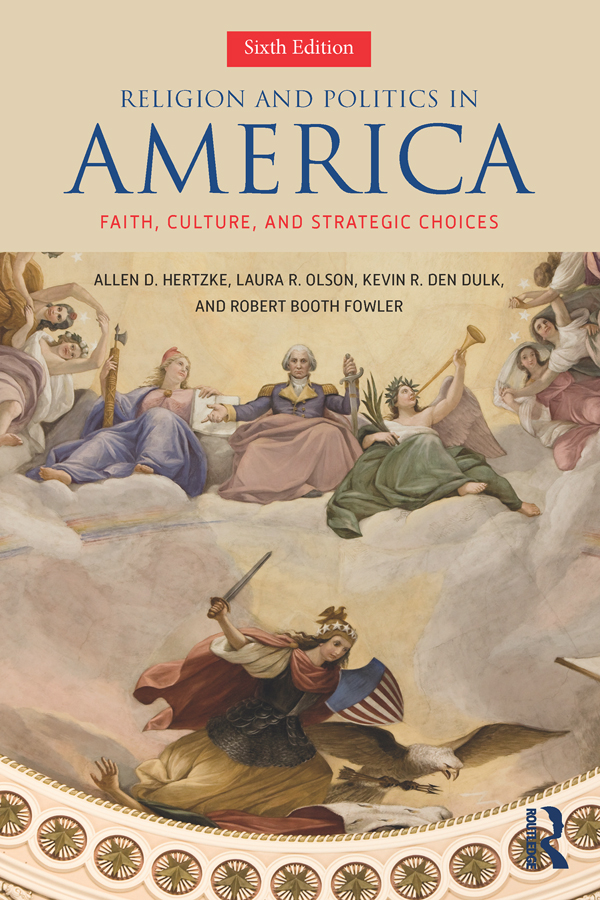
Religion and Politics in America Religion and politics are never far from the headlines, but their relationship remains complex and often confusing. This book offers an engaging, accessible, and balanced treatment of religion in American politics. It explores the historical, cultural, and legal contexts that motivate religious political engagement and assesses the pragmatic and strategic political realities that religious organizations and people face. Incorporating the best and most current scholarship, the authors examine the evolving politics of Roman Catholics; evangelical and mainline Protestants; African-American and Latino traditions; Jews, Muslims, and other religious minorities; recent immigrants and religious "nones"; and other conventional and not-so-conventional American religious movements. New to the Sixth Edition • Covers the 2016 election and assesses the role of religion from Obama to Trump. • Expands substantially on religion’s relationship to gender and sexuality, race, ethnicity, and class, and features the role of social media in religious mobilization. • Adds discussion questions at the end of every chapter, to help students gain deeper understanding of the subject. • Adds a new concluding chapter on the normative issues raised by religious political engagement, to stimulate lively discussions. POLITICAL SCIENCE,General
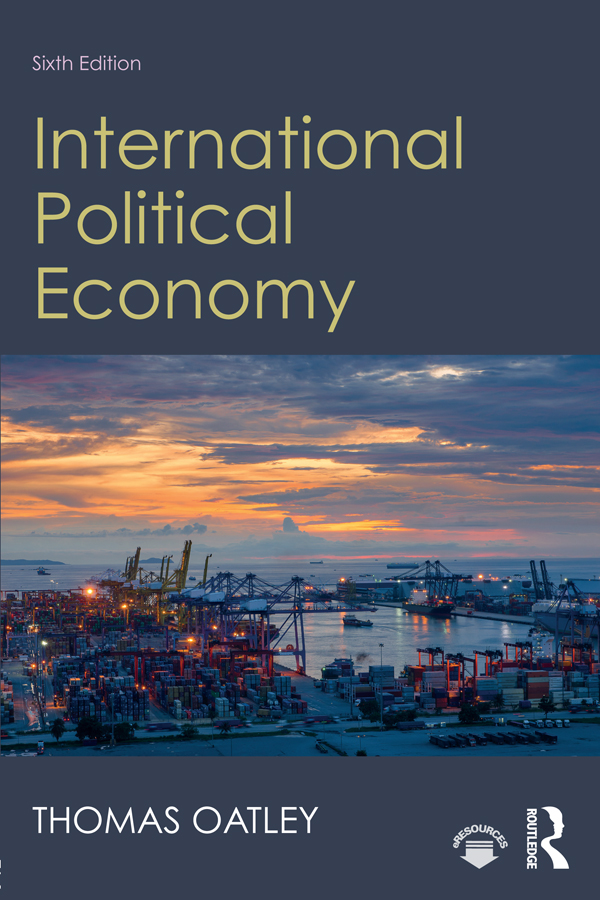
International Political Economy Broadly viewing the global economy as a political competition that produces winners and losers, International Political Economy holistically and accessibly introduces the field of IPE to students with limited background in political theory, history, and economics. This text surveys major interests and institutions and examines how state and non-state actors pursue wealth and power. Emphasizing fundamental economic concepts as well as the interplay between domestic and international politics, International Political Economy not only explains how the global economy works, it also encourages students to think critically about how economic policy is made in the context of globalization. New to the Sixth Edition Covers the economic impacts of 2016 electoral events, including new Trump administration initiatives related to TPP and NAFTA; the UK and Brexit, and the European populist wave. Examines the global financial crisis, EU debt crisis, quantitative easing, global capital flow cycles, and currency wars. Probes the death of the Doha Round and explores individual trade preferences, WTO dispute settlement, bilateral investment treaties and global value chains, labor standards, and the role of institutions for economic development. Considers how U.S. monetary and fiscal policy shapes the flow of financial capital into and out of emerging market economies with a focus on the "Fragile Five," whether the Chinese Renminbi can displace the dollar as a global currency, and the newly constructed Asian Infrastructure Investment Bank. Explores the impact of migration on wages and income inequality, and the growing importance of working remittances as a source of capital for developing countries. POLITICAL SCIENCE,General
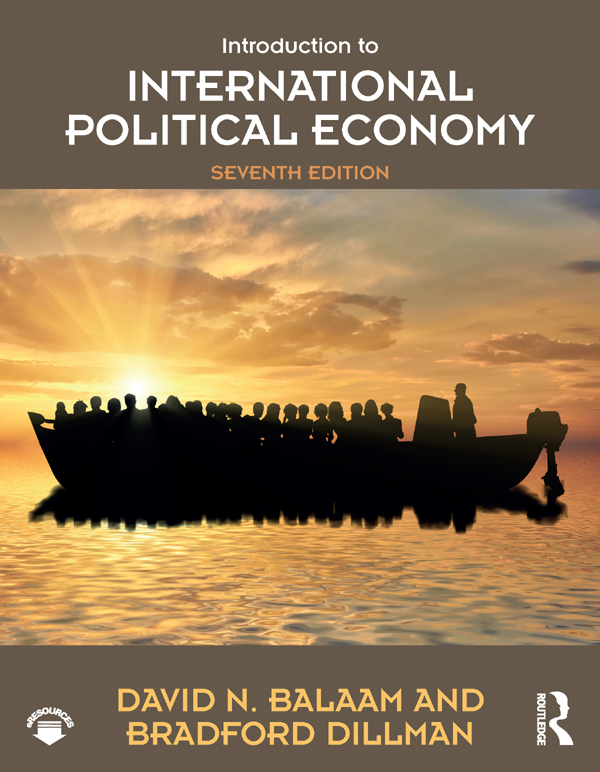
Introduction to International Political Economy In a revolutionary revision of this best-selling text, David Balaam and Bradford Dillman show how the postwar world order is at once under threat and yet resilient. This classic text surveys the theories, institutions, and relationships that characterize IPE and highlights them in the context of a diverse range of regional and transnational issues. Introduction to International Political Economy positions students to critically evaluate the global economy and to appreciate the personal impact of political, economic, and social forces. New to the Seventh Edition Streamlined yet comprehensive coverage—reducing the text from 20 to 17 chapters. There is also one unified chapter on global finance and a single chapter on energy and the environment. A new chapter on Constructivism shows sociological and ideational forces at work. A new chapter on Global Production encompasses transnational corporations and labor. A new chapter on Global Health incorporates food and refugee issues. Substantial revisions to 10 chapters, including new material on Brexit, the EU debt and refugee crises, populist-nationalist movements, inequality, trade conflicts and negotiations, cyber weapons, the rise of China, Middle East conflicts, and international responses to climate change. Significant focus throughout on President Trump’s impact on U.S. foreign policy, international order, and global security. Extensive new graphs and tables of data, plus 27 fascinating new text boxes throughout. An author-written Instructor’s Manual and Test Bank are provided along with additional online resources. POLITICAL SCIENCE,General
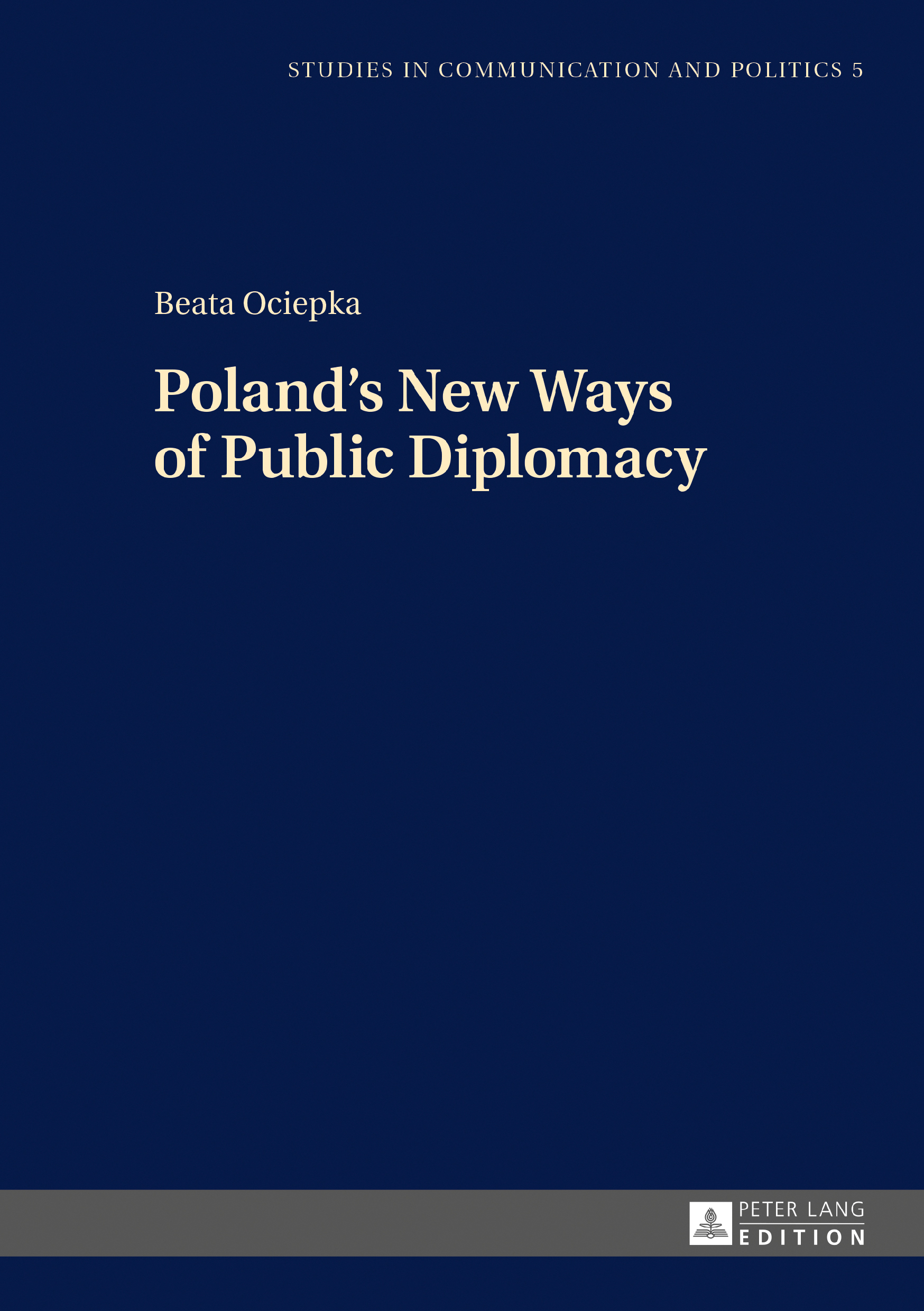
Poland’s New Ways of Public Diplomacy This book analyzes when and how Poland implemented public diplomacy. The author explains it as a form of external political communication of governments conducted in cooperation with non-state actors to position the country internationally. The Polish case illustrates how a mid-size country in Europe attempts to impact the public opinion formation abroad while implementing soft power tools. Since 2004, when Poland joined the EU, the country has used public diplomacy to inform the world about its achievements. Poland’s public diplomacy has been strongly oriented on Europe and shaped by geopolitics. It integrated transmission and network models of communication. The Polish model reflects the relevance of public diplomacy domestic dimension and the focus on foreign politics on memory. «The book (…) is the first monograph analyzing contemporary Polish public diplomacy written in English, being at the same time a methodologically sound piece of research, based on extensive primary source research.» Professor Andrzej Mania, Chair of American Studies and the History of Diplomacy and International Politics, Jagiellonian University «An excellent case study of public diplomacy. Ociepka systematically analyzed the Polish utilization of key public diplomacy instruments including cultural diplomacy, branding and Twiplomacy, and properly placed them within historical and theoretical contexts.» Professor Eytan Gilboa, Director, Center for International Communication, Bar-Ilan University POLITICAL SCIENCE,General
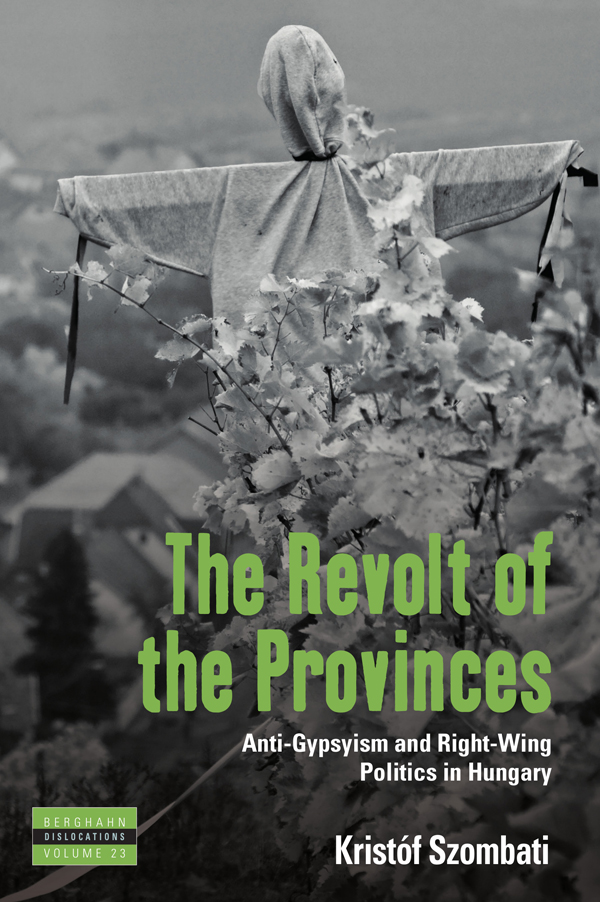
The Revolt of the Provinces The first in-depth ethnographic monograph on the New Right in Central and Eastern Europe, The Revolt of the Provinces explores the making of right-wing hegemony in Hungary over the last decade. It explains the spread of racist sensibilities in depressed rural areas, shows how activists, intellectuals and politicians took advantage of popular racism to empower right-wing agendas and examines the new ruling party's success in stabilizing an 'illiberal regime'. To illuminate these important dynamics, the author proposes an innovative multi-scalar and relational framework, focusing on interaction between social antagonisms emerging on the local level and struggles waged within the political public sphere. POLITICAL SCIENCE,General
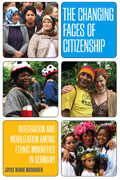
The Changing Faces of Citizenship In contrast to most migration studies that focus on specific “foreigner†groups in Germany, this study simultaneously compares and contrasts the legal, political, social, and economic opportunity structures facing diverse categories of the ethnic minorities who have settled in the country since the 1950s. It reveals the contradictory, and usually self-defeating, nature of German policies intended to keep “migrants†out—allegedly in order to preserve a German Leitkultur (with which very few of its own citizens still identify). The main barriers to effective integration—and socioeconomic revitalization in general—sooner lie in the country’s obsolete labor market regulations and bureaucratic procedures. Drawing on local case studies, personal interviews, and national surveys, the author describes “the human faces†behind official citizenship and integration practices in Germany, and in doing so demonstrates that average citizens are much more multi-cultural than they realize. POLITICAL SCIENCE,General
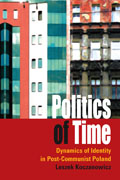
Politics of Time What has really happened in Poland since the election of 2005? After such spectacular events as the practice of lustration and the questioning of solidarity with the European Union, one has to ask: what is the nature of this newly emerging society? As with many of the recent developments in former communist countries that seem to be mysterious and irrational, the situation and ensuing problems are complex and the answers neither trivial nor easy. This book, by the distinguished Polish philosopher, addresses these complexities through the role of the communist past in post-communist Poland. It describes the events that led to the collapse of the Solidarity program and the growing influence of the nationalistic and religious parties in the government. The author investigates the nature of social and political temporality and develops a theoretical framework that allows him to apply his conclusions not only to Poland but also to other formerly communist countries. POLITICAL SCIENCE,General
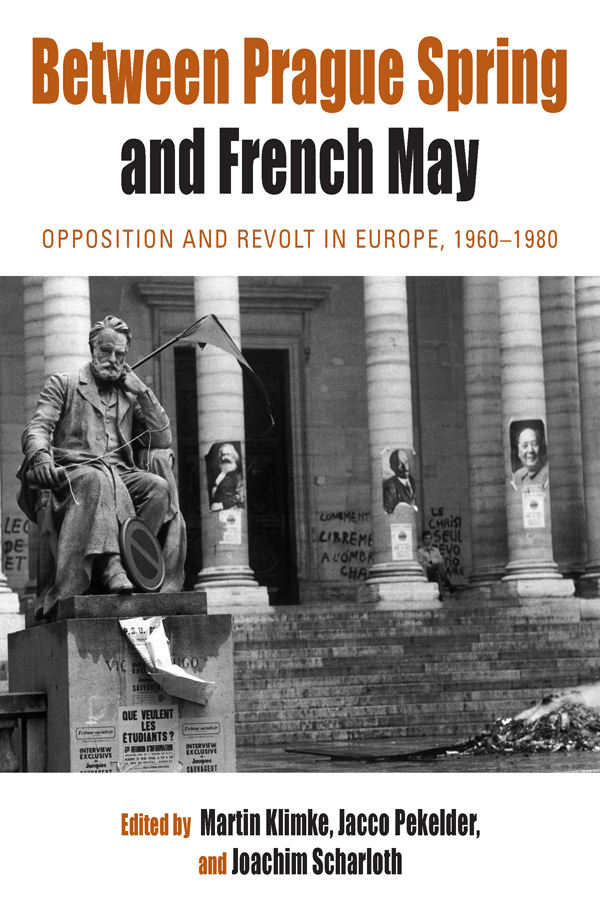
Between Prague Spring and French May Abandoning the usual Cold War–oriented narrative of postwar European protest and opposition movements, this volume offers an innovative, interdisciplinary, and comprehensive perspective on two decades of protest and social upheaval in postwar Europe. It examines the mutual influences and interactions among dissenters in Western Europe, the Warsaw Pact countries, and the nonaligned European countries, and shows how ideological and political developments in the East and West were interconnected through official state or party channels as well as a variety of private and clandestine contacts. Focusing on issues arising from the cross-cultural transfer of ideas, the adjustments to institutional and political frameworks, and the role of the media in staging protest, the volume examines the romanticized attitude of Western activists to violent liberation movements in the Third World and the idolization of imprisoned RAF members as martyrs among left-wing circles across Western Europe. POLITICAL SCIENCE,General
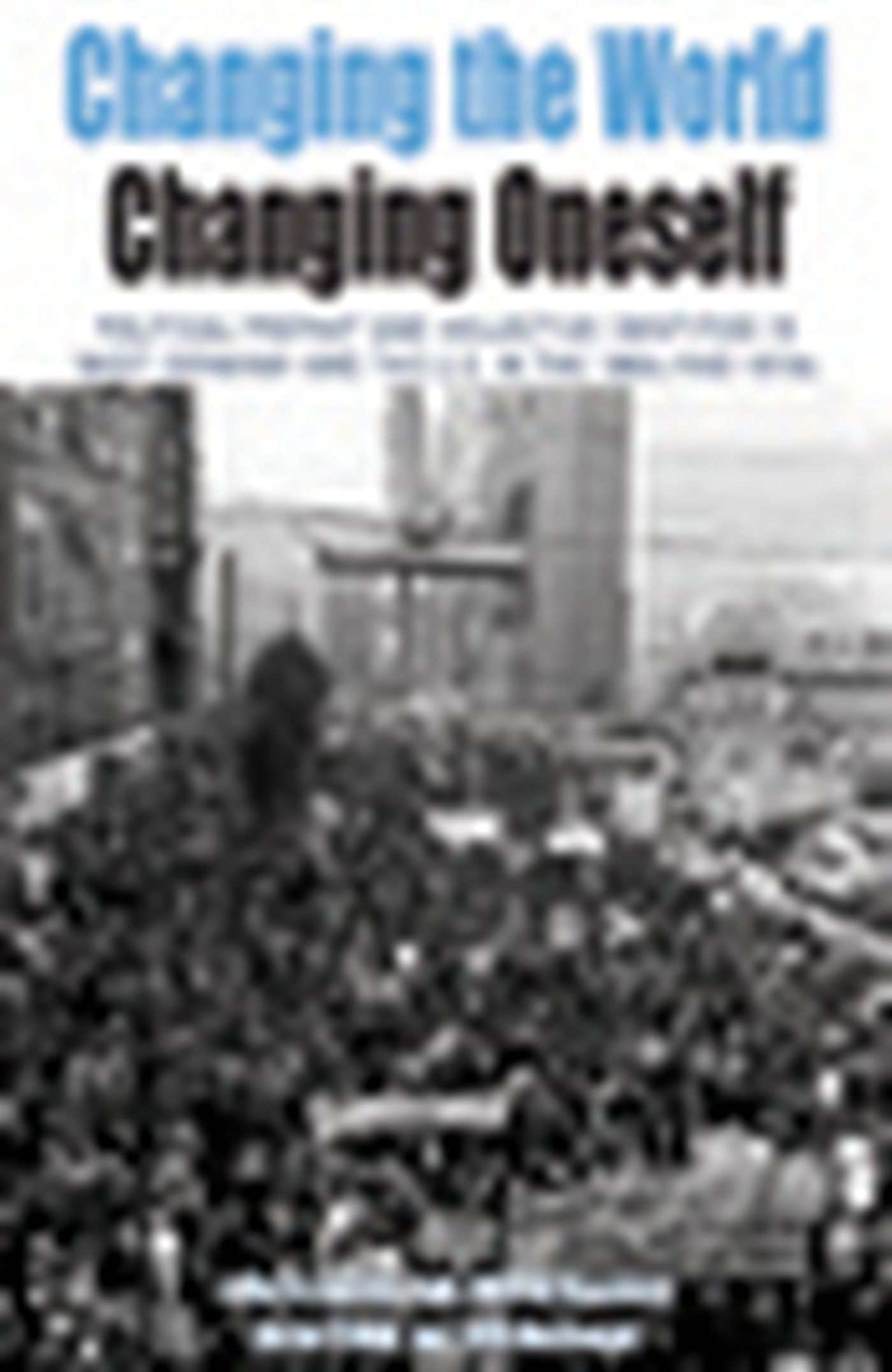
Changing the World, Changing Oneself A captivating time, the 60s and 70s now draw more attention than ever. The first substantial work by historians has appeared only in the last few years, and this volume offers an important contribution. These meticulously researched essays offer new perspectives on the Cold War and global relations in the 1960s and 70s through the perspective of the youth movements that shook the U.S., Western Europe, and beyond. These movements led to the transformation of diplomatic relations and domestic political cultures, as well as ideas about democracy and who best understood and promoted it. Bringing together scholars of several countries and many disciplines, this volume also uniquely features the reflections of former activists. POLITICAL SCIENCE,General

A European Memory? An examination of the role of history and memory is vital in order to better understand why the grand design of a United Europe—with a common foreign policy and market yet enough diversity to allow for cultural and social differences—was overwhelmingly turned down by its citizens. The authors argue that this rejection of the European constitution was to a certain extent a challenge to the current historical grounding used for further integration and further demonstrates the lack of understanding by European bureaucrats of the historical complexity and divisiveness of Europe’s past. A critical European history is therefore urgently needed to confront and re-imagine Europe, not as a harmonious continent but as the outcome of violent and bloody conflicts, both within Europe as well as with its Others. As the authors show, these dark shadows of Europe’s past must be integrated, and the fact that memories of Europe are contested must be accepted if any new attempts at a United Europe are to be successful. POLITICAL SCIENCE,General
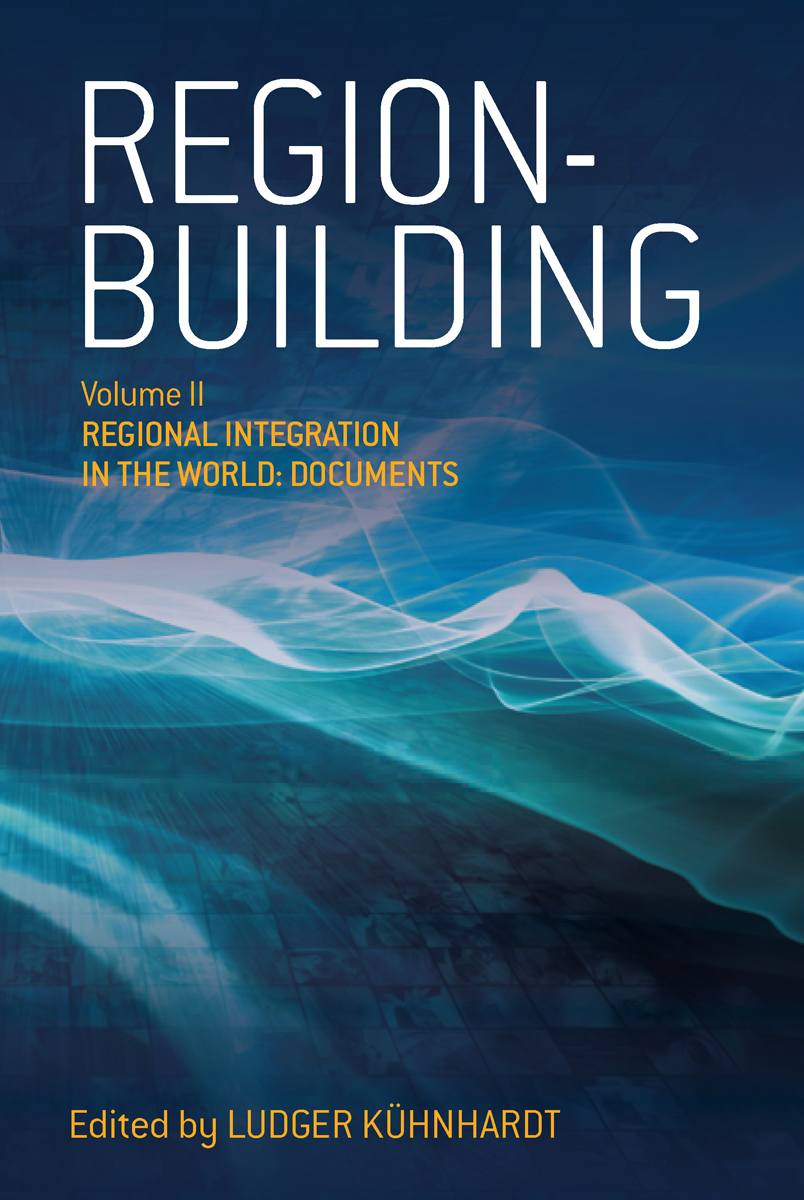
Region-building After two centuries of nation-building, the world has entered an era of region-building in search of political stability, cultural cohesion, and socio-economic development. Nations involved in the regional structures and integration schemes that are emerging in most regions of the world are deepening their ambitions, with Europe’s integration experience often used as an experimental template or theoretical model. Volume I provides a political-analytical framework for recognizing the central role of the European Union not only as a conceptual model but also a normative engine in the global proliferation of regional integration. It also gives a comprehensive treatment of the focus, motives, and objectives of non-European integration efforts. Volume II offers a unique collection of documents that give the best available overview of the legal and political evolution of region-building based on official documents and stated objectives of the relevant regional groupings across all continents. Together, these volumes are important contributions for understanding the evolution of global affairs in an age when power shifts provide new challenges and opportunities for transatlantic partners and the world community. POLITICAL SCIENCE,General
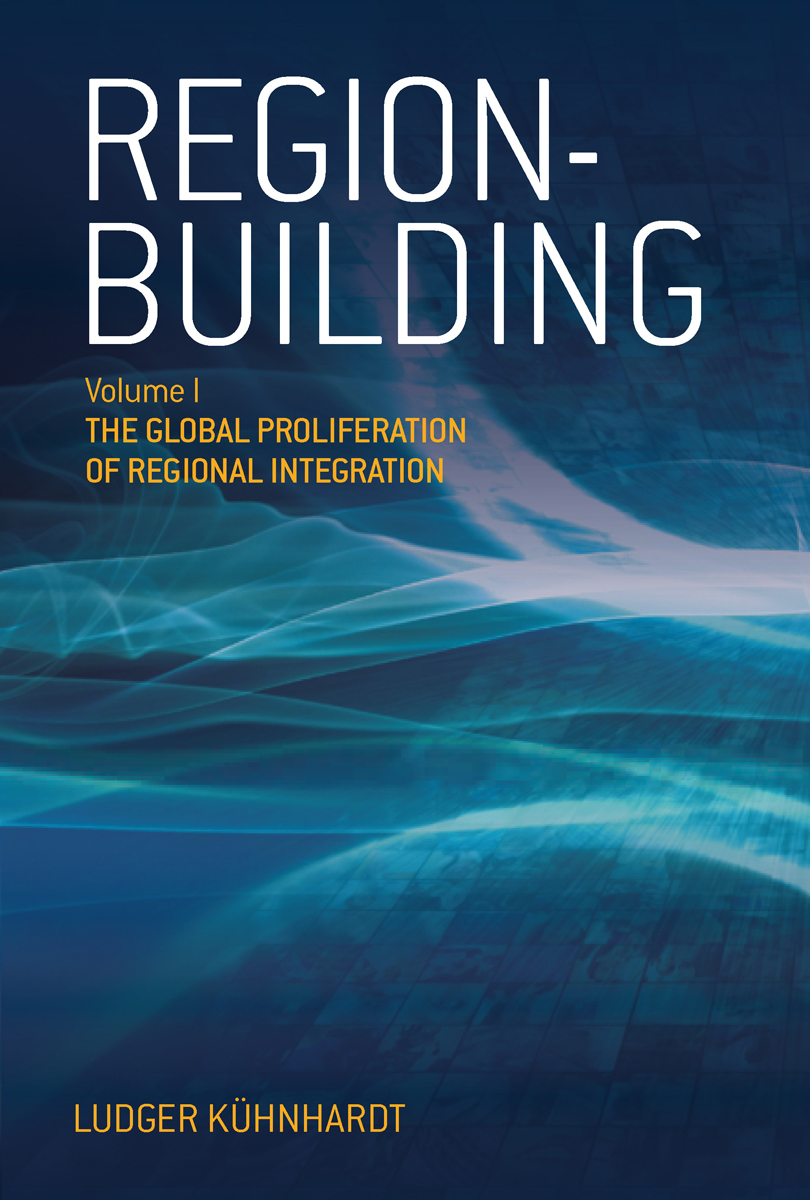
Region-building After two centuries of nation-building, the world has entered an era of region-building in search of political stability, cultural cohesion, and socio-economic development. Nations involved in the regional structures and integration schemes that are emerging in most regions of the world are deepening their ambitions, with Europe’s integration experience often used as an experimental template or theoretical model. Volume I provides a political-analytical framework for recognizing the central role of the European Union not only as a conceptual model but also a normative engine in the global proliferation of regional integration. It also gives a comprehensive treatment of the focus, motives, and objectives of non-European integration efforts. Volume II offers a unique collection of documents that give the best available overview of the legal and political evolution of region-building based on official documents and stated objectives of the relevant regional groupings across all continents. Together, these volumes are important contributions for understanding the evolution of global affairs in an age when power shifts provide new challenges and opportunities for transatlantic partners and the world community. POLITICAL SCIENCE,General

State Collapse and Reconstruction in the Periphery In the 1990s, Yugoslavia, which had once been a role model for development, became a symbol for state collapse, external intervention and post-war reconstruction. Today the region has two international protectorates, contested states and borders, severe ethnic polarization and minority concerns. In this first in-depth critical analysis of international administration, aid and reconstruction policies in Kosovo, Jens Stilhoff Sörensen argues that the region must be analyzed as a whole, and that the process of state collapse and recent changes in aid policy must be interpreted in connection to the wider transformation of the global political economy and world order. He examines the shifting inter- and intracommunity relations, the emergence of a "political economy" of conflict, and of informal clientelist arrangements in Serbia and Kosovo and provides a framework for interpreting the collapse of the Yugoslav state, the emergence of ethnic conflict and shadow economies, and the character of western aid and intervention. Western governments and agencies have built policies on conceptions and assumptions for which there is no genuine historical or contemporary economic, social or political basis in the region. As the author persuasively argues, this discrepancy has exacerbated and cemented problems in the region and provided further complications that are likely to remain for years to come. POLITICAL SCIENCE,General

Protest Beyond Borders The protest movements that followed the Second World War have recently become the object of study for various disciplines; however, the exchange of ideas between research fields, and comparative research in general, is lacking. An international and interdisciplinary dialogue is vital to not only describe the similarities and differences between the single national movements but also to evaluate how they contributed to the formation and evolution of a transnational civil society in Europe. This volume undertakes this challenge as well as questions some major assumptions of post-1945 protest and social mobilization both in Western and Eastern Europe. Historians, political scientists, sociologists and media studies scholars come together and offer insights into social movement research beyond conventional repertoires of protest and strictly defined periods, borders and paradigms, offering new perspectives on past and present processes of social change of the contemporary world. POLITICAL SCIENCE,General

The Politics of European Citizenship As the European Union faces the ongoing challenges of legitimacy, identity, and social cohesion, an understanding of the social purpose and direction of EU citizenship becomes increasingly vital. This book is the first of its kind to map the development of EU citizenship and its relation to various localities of EU governance. From a critical political economy perspective, the authors argue for an integrated analysis of EU citizenship, one that considers the interrelated processes of migration, economic transformation, and social change and the challenges they present. POLITICAL SCIENCE,General
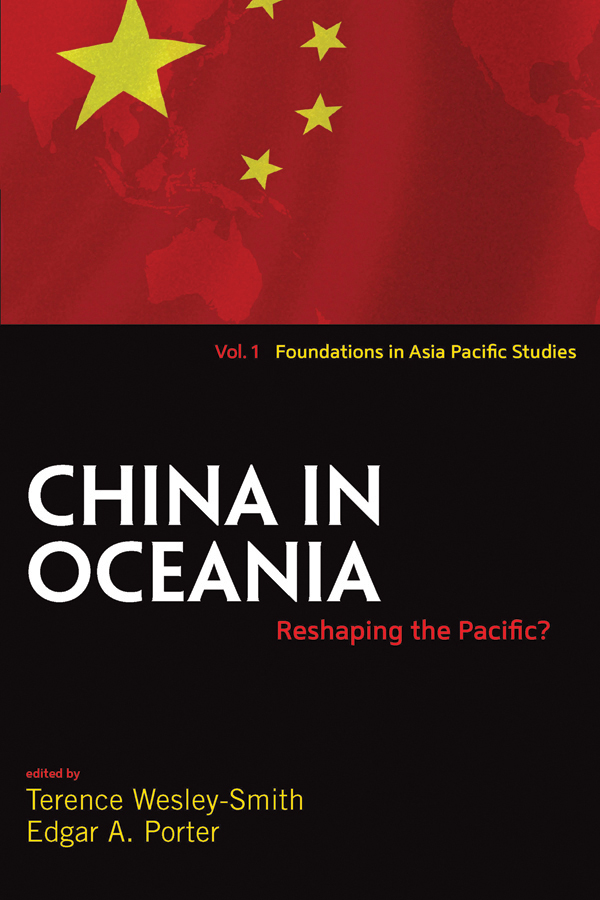
China in Oceania It is important to see China’s activities in the Pacific Islands, not just in terms of a specific set of interests, but in the context of Beijing’s recent efforts to develop a comprehensive and global foreign policy. China’s policy towards Oceania is part of a much larger outreach to the developing world, a major work in progress that involves similar initiatives in Asia, Africa, Latin America, and the Middle East. This groundbreaking study of China’s “soft power†initiatives in these countries offers, for the first time, the diverse perspectives of scholars and diplomats from Oceania, North American, China, and Japan. It explores such issues as regional competition for diplomatic and economic ties between Taiwan and China, the role of overseas Chinese in developing these relationships, and various analyses of the benefits and drawbacks of China’s growing presence in Oceania. In addition, the reader obtains a rare review of the Japanese response to China’s role in Oceania, presented by Japan’s leading scholar of the Pacific region. POLITICAL SCIENCE,General

The Golden Chain The family can be viewed as one of the links in a “golden chain†connecting individuals, the private sphere, civil society, and the democratic state; as potentially an important source of energy for social activity; and as the primary institution that socializes and diffuses the values and norms that are of fundamental importance for civil society. Yet much of the literature on civil society pays very little attention to the complex relations between civil society and the family. These two spheres constitute a central element in democratic development and culture and form a counterweight to some of the most distressing aspects of modernity, such as the excessive privatization of home life and the unceasing work-and-spend routines. This volume offers historical perspectives on the role of families and their members in the processes of a liberal and democratic civil society, the question of boundaries and intersections of the private and public domains, and the interventions of state institutions. POLITICAL SCIENCE,General

Central America in the New Millennium Most non-Central Americans think of the narrow neck between Mexico and Colombia in terms of dramatic past revolutions and lauded peace agreements, or sensational problems of gang violence and natural disasters. In this volume, the contributors examine regional circumstances within frames of democratization and neoliberalism, as they shape lived experiences of transition. The authors—anthropologists and social scientists from the United States, Europe, and Central America—argue that the process of regions and nations “disappearing†(being erased from geopolitical notice) is integral to upholding a new, post-Cold War world order—and that a new framework for examining political processes must be accessible, socially collaborative, and in dialogue with the lived processes of suffering and struggle engaged by people in Central America and the world in the name of democracy. POLITICAL SCIENCE,General
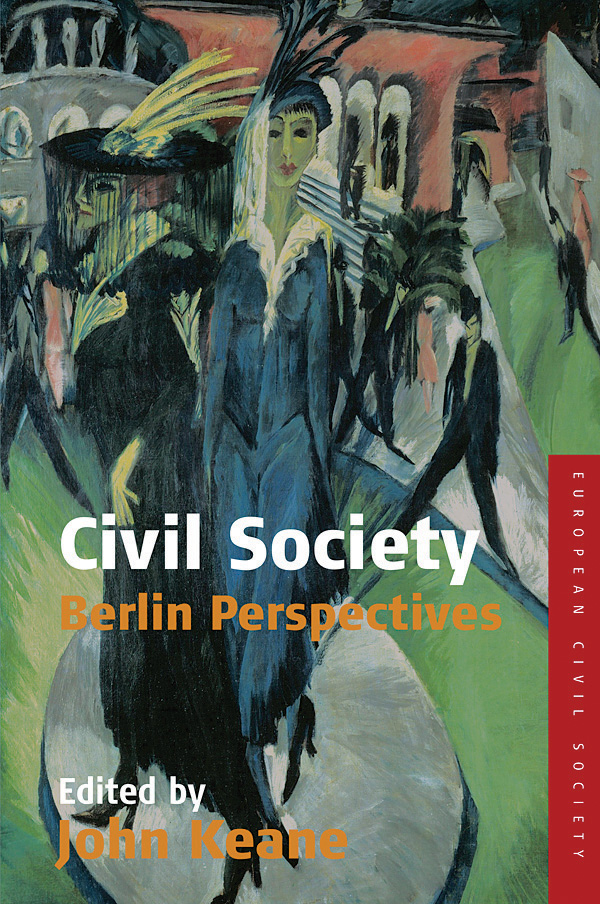
Civil Society At the moment, no other European city attracts so much fascination as the city of Berlin. An unrivalled symbol of modern urban life, Berlin is a dynamic city whose inhabitants, in the course of the past two centuries, have lived through both the rapid growth and the violent destruction of the institutions of civil society, several times over. This volume situates itself within these developments by presenting, for the first time in English, a sample of the best, recently written essays on contemporary civil societies, their structural problems, and their uncertain future, written by scholars with a close, long-standing relationship with the city. They are pre-occupied with a broad sweep of substantive themes, but in each case they focus upon one or other of the key trends that are shaping actually existing civil societies. POLITICAL SCIENCE,General

The French Exception The notion of French exceptionalism is deeply embedded in the nation's self-image and in a range of political and academic discourses. Recently, the debate about whether France really is "exceptional" has acquired a critical edge. Against the background of introspection about the nature of "national identity," some proclaim "normalisation" and the end of French exceptionalism, while others point out to the continuing evidence that France remains distinctive at a number of levels, from popular culture to public policy. This book explores the notion of French exceptionalism, places it in its European context, examines its history and evaluate its continuing relevance in a range of fields from politics and public policy to popular culture and sport. POLITICAL SCIENCE,General
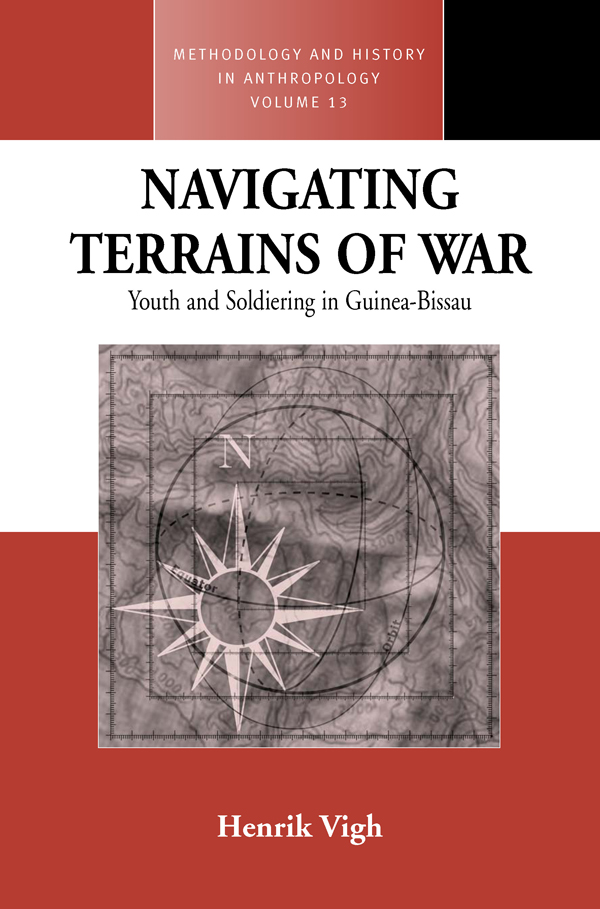
Navigating Terrains of War Through the concept of "social navigation," this book sheds light on the mobilization of urban youth in West Africa. Social navigation offers a perspective on praxis in situations of conflict and turmoil. It provides insights into the interplay between objective structures and subjective agency, thus enabling us to make sense of the opportunistic, sometimes fatalistic and tactical ways in which young people struggle to expand the horizons of possibility in a world of conflict, turmoil and diminishing resources. POLITICAL SCIENCE,General

French Intellectuals Against the Left In the latter half of the 1970s, the French intellectual Left denounced communism, Marxism, and revolutionary politics through a critique of left-wing totalitarianism that paved the way for today's postmodern, liberal, and moderate republican political options. Contrary to the dominant understanding of the critique of totalitarianism as an abrupt rupture induced by Aleksandr Solzhenitsyn's The Gulag Archipelago, Christofferson argues that French anti-totalitarianism was the culmination of direct-democratic critiques of communism and revisions of the revolutionary project after 1956. The author's focus on the direct-democratic politics of French intellectuals offers an important alternative to recent histories that seek to explain the course of French intellectual politics by France's apparent lack of a liberal tradition. POLITICAL SCIENCE,General
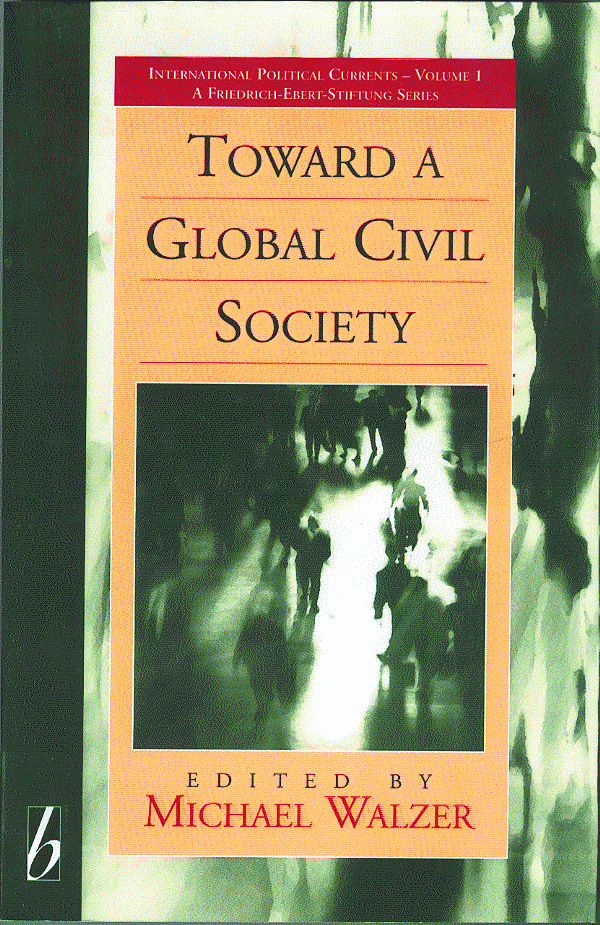
Toward a Global Civil Society The demise of Communism has not only affected Eastern Europe but also the countries of the West where a far-reaching examination of political and economic systems has begun. This collection of essays by internationally renowned scholars of political theory from Europe and the United States explores both the concept and the reality of civil society and its institutions. POLITICAL SCIENCE,General

Hizbullah Hizbullah ('Party of God') is one of the Middle East's major political forces. Sheikh Naim Qassem, its Deputy Secretary-General, provides and insider's view of this Shi'ite resistance group turned political party, from its inception to the present day. Formed in 1982 in response to Israel's invasion of Lebanon, Hizbullah was instrumental in forcing Israel to withdraw its troops in 2000. During the 1990s, after many years functioning as both a guerrilla movement and a social-support provider to Lebanese victims of war, Hizbullah moved into mainstream parliamentary politi. The group's mandate is laid out here, allowing access to the mindset of this important party at a crucial stage of its development. 'A comprehensive guide to the mandate of one of the Middle East's major political forces.' Washington Report on Middle Eastern Affairs 'A fascinating account of the creation and rise of Hizbullah.' London Review of Books POLITICAL SCIENCE,General
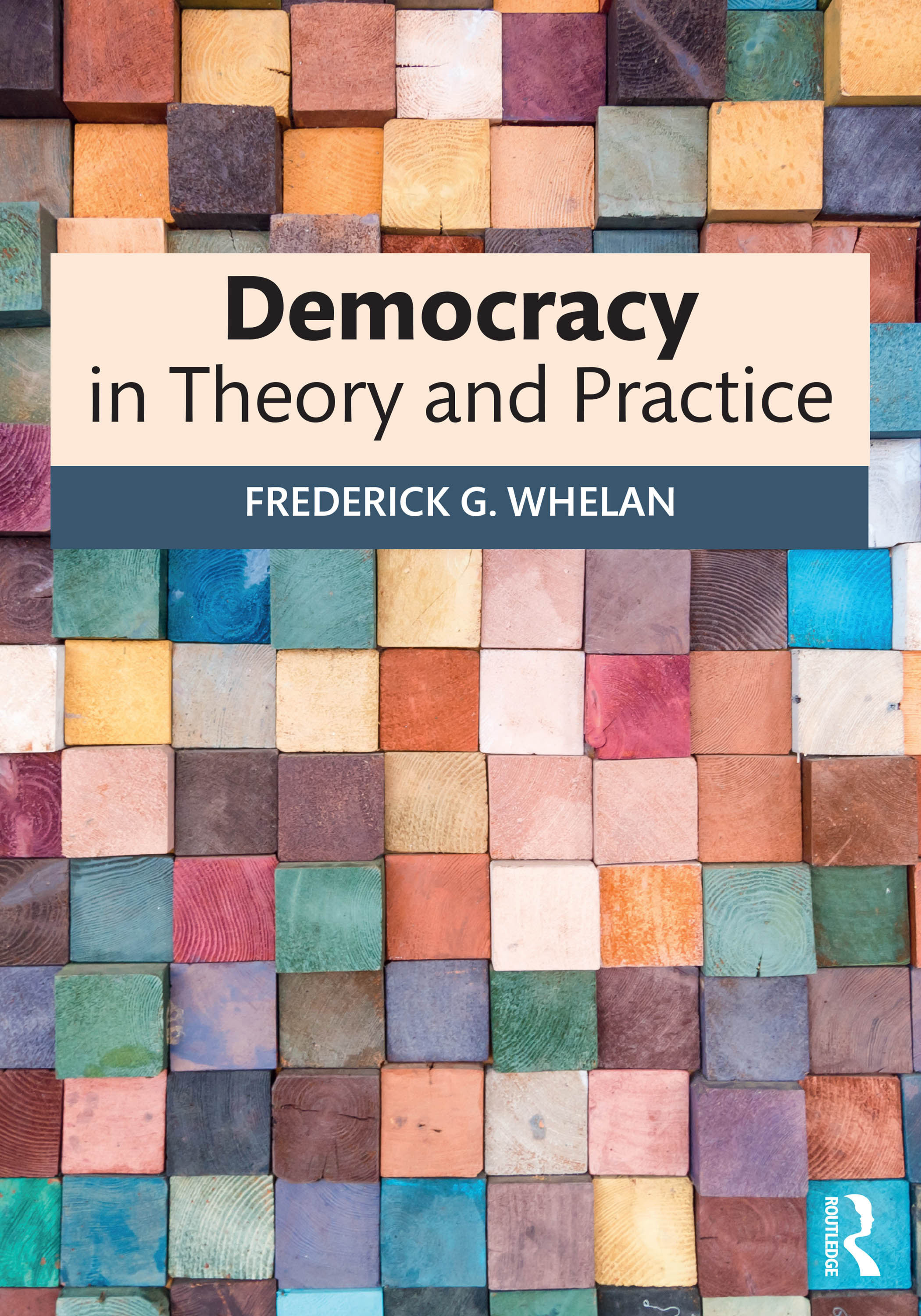
Democracy in Theory and Practice Democracy in Theory and Practice presents an authoritative overview of democratic theory today. Its distinctive approach links theory to practice, emphasizing the wide variety of institutions and procedures through which core democratic principles are implemented and the normative and practical dimensions of the choices to be made among these alternatives. Designed for courses at both the undergraduate and graduate level, the book features eighteen chapters organized thematically and divided into sections and subsections for easy reference; historical and current examples, citations for specific ideas, annotated references, and further readings throughout enhance the volume's utility for students, scholars, and researchers. Sidebars give biographical sketches of classic theorists and democratic ideas from the US founders and constitutional tradition. Featured topics discussed include: Majority Rule; Participation; Deliberation; Accountability; Representation; Constitutionalism; Electoral Laws; Parties; Legislative, Executive, and Judicial Functions. The Boundary Problem; The "All-Affected" Principle; Contested Senses of Liberal and Procedural Democracy; The Pros and Cons of Term Limits; Proportional Representation; Referendums; Problems of Democratic Transparency and Reversibility. Written by a leading authority in the field, Frederick G. Whelan encourages us to think of the many alternative ways of putting democracy into practice and of these alternatives as requiring choices. This diversity means that there is no unique or correct democratic outcome from a given set of preferences, since outcomes are shaped by the methods followed in reaching them. POLITICAL SCIENCE,General
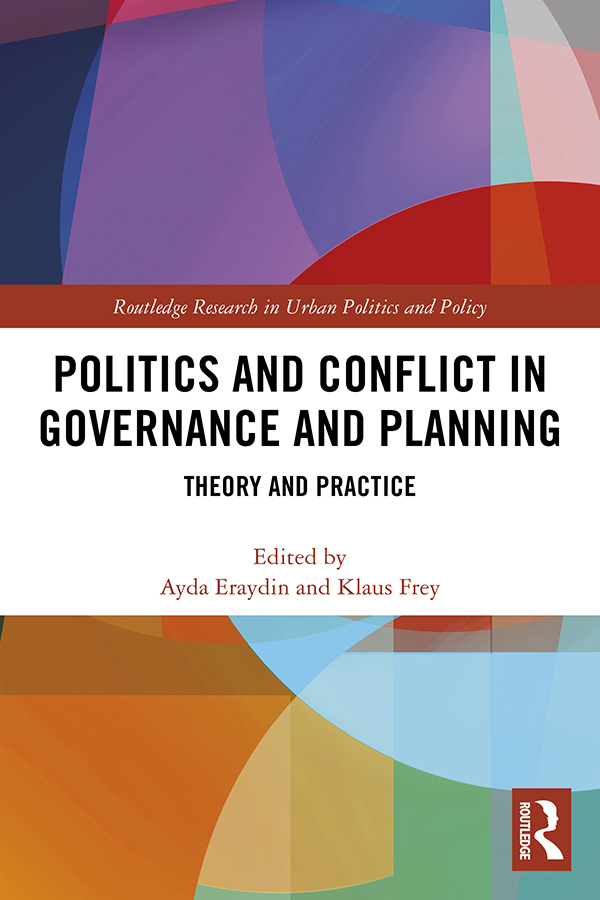
Politics and Conflict in Governance and Planning Politics and Conflict in Governance and Planning offers a critical evaluation of manifold ways in which the political dimension is reflected in contemporary planning and governance. While the theoretical debates on post-politics and the wider frame of post-foundational political theory provide substantive explanations for the crisis in planning and governance, still there is a need for a better understanding of how the political is manifested in the planning contents, shaped by institutional arrangements and played out in the planning processes. This book undertakes a reassessment of the changing role of the political in contemporary planning and governance. Employing a wide range of empirical research conducted in several regions of the world, it draws a more complex and heterogeneous picture of the context-specific depoliticisation and repoliticisation processes taking place in local and regional planning and governance. It shows not only the domination of market forces and the consequent suppression of the political but also how political conflicts and struggles are defined, tackled and transformed in view of the multifaceted rules and constraints recently imposed to local and regional planning. Switching the focus to how strategies and forms of depoliticised governance can be repoliticised through renewed planning mechanisms and socio-political mobilisation, Politics and Conflict in Governance and Planning is a critical and much needed contribution to the planning literature and its incorporation of the post-politics and post-democracy debate. POLITICAL SCIENCE,General
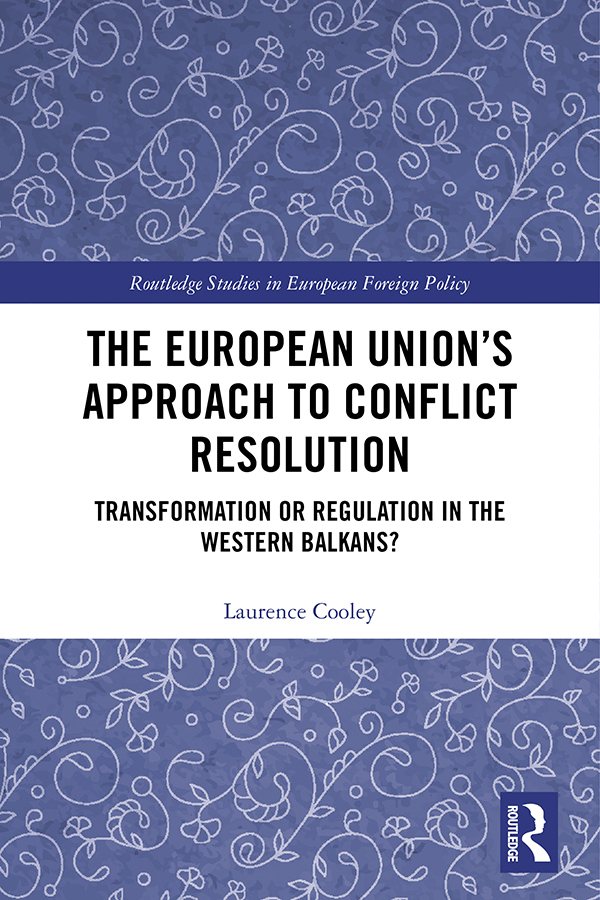
The European Union’s Approach to Conflict Resolution This book investigates and explains the European Union’s approach to conflict resolution in three countries of the Western Balkans: Bosnia and Herzegovina, Macedonia and Kosovo. In doing so, it critically interrogates claims that the EU acts as an agent of conflict transformation in its engagement with conflict-affected states. The book argues, contrary to the assumptions of much of the existing literature, that rather than seeking the transformation of conflicts, the EU pursues a more conservative strategy based on the regulation of conflict through the promotion of institutional mechanisms such as consociational power sharing and decentralisation. Drawing on discourse analysis of documents, speeches, and interviews conducted by the author with European Union officials and policy-makers in Brussels and the case-study countries, the book offers a theoretically grounded, methodologically rigorous and empirically detailed analysis of EU policy preferences, of the ideas that underpin them, and of how those preferences are legitimised. This book will be of key interest to scholars, students and practitioners interested in ethnic conflict and conflict resolution, the politics of the Balkans, and the external and foreign policies of the EU. POLITICAL SCIENCE,General

You Are Not Human In Nazi Germany, Hitler portrayed the Jews as vermin and six million people were killed. Metaphors can make the unreasonable seem reasonable, the illegitimate appear legitimate, and good people turn evil. Top speechwriter Simon Lancaster goes on a mission to explore how metaphors are used and abused today. From Washington to Westminster, Silicon Valley to Syria, Glastonbury to Grenfell, he discovers the same images being used repeatedly. Scum! Bitch! Vegetable! Whilst vulnerable groups are dehumanised, the powerful are hailed as stars, angels or even gods. Prepare to take a journey into the surreal. This book raises profound questions about the power of language and the language of power. You will never think about words in the same way again. POLITICAL SCIENCE,General

Politically Un-Correct Get ready for some candid views on politics and society that are Politically Un-Correct. Yes, you read that rightun-correct. Author Robert Alan, a military veteran, lifelong worker, and patriot, takes Americas politicians to task and calls for real leadership to get the country back on track. He attacks the wasteful spending by members of Congress, the misguided policies of President Barack Obama, the abuse of foreign aid, and much more. More importantly, he offers a blueprint to solve our most serious problems, which includeseliminating the US Senate and transferring its responsibilities to the House of Representatives;mandating that no one in the unicameral Congress serve more than eight years in office;passing an amendment that denies Congress the right to exempt itself from any laws. Its time for the government to stop spending money it doesnt have while sending out thugs from the Internal Revenue Service to collect from its hardworking people. Learn more about Alans un-correct views, and join him at the ballot box to throw out the thieves and scalawags that are ruining the United States of America. POLITICAL SCIENCE,General

The Use of Force under International Law The international system is becoming increasingly legalized, with legal arguments and legal advisors playing an increasingly important part in the state policymaking process. Presenting a practice-oriented theory of compliance with international law, this book shows how international law affects the behavior of increasingly lawyerized states in an ever more legalized world. By highlighting the legalization of international legitimation and the lawyerization of policymaking as the new engines of compliance, the book’s analytical framework rethinks the relationship between state behavior and international law, and provides an empirical focus on security through the study of NATO’s military intervention in Yugoslavia in 1999 and the changes in the US detention and interrogation programs in the "War on Terror." Relying on primary sources, the author demonstrates the effect of lawyerized decision making on international law compliance, reconstructing the strategies of (de-)legitimation used to show that international law is the hegemonic frame of reference in interstate debates. This book will be of interest to scholars of international relations, government studies, foreign service studies and lawyers employed in government work. POLITICAL SCIENCE,General

The European Union at an Inflection Point The cutting-edge contributions to this book analyse different facets of the European Union (EU): closer integration among the member states, policymaking within a ‘normal’ political system, and the implications of European integration for its member states. This book also considers whether the challenges currently confronting the EU – the lingering Eurozone debt crises, the migrant/refugee crisis, the British decision to leave the EU, and terrorist attacks in Belgium, France and Germany – mark an inflection point for the Union and for the study of the EU. For the first time, ‘less Europe’, rather than closer integration, has emerged as a serious option in response to crisis. This possibility reignites questions of (dis)integration and calls into question the assumption of the EU as a ‘normal’ political system. This book was originally published as a special issue of the Journal of European Public Policy. POLITICAL SCIENCE,General

The British General Election of 2017 The British General Election of 2017 is the definitive and authoritative account of one of the most dramatic elections in British history. Throwing aside her natural caution, Theresa May called a snap election and was widely expected to crush Jeremy Corbyn’s Labour Party. Her gamble backfired spectacularly as the Conservatives lost their Commons majority to a resurgent Labour led by one of the most unconventional politicians to lead a major British political party. Drawing on hundreds of interviews, with unparalleled access to all the key players, The British General Election of 2017 offers a revelatory guide to what really happened. The 20th edition in this prestigious series of books dating back to 1945, it is designed to appeal to everyone — from Westminster insiders and politics students to the wider general public. POLITICAL SCIENCE,General

Black Politics in Transition Black Politics in Transition considers the impact of three transformative forces—immigration, suburbanization, and gentrification—on Black politics today. Demographic changes resulting from immigration and ethnic blending are dramatically affecting the character and identity of Black populations throughout the US. Black Americans are becoming more ethnically diverse at the same time that they are sharing space with newcomers from near and far. In addition, the movement of Black populations out of the cities to which they migrated a generation ago—a reverse migration to the American South, in some cases, and in other cases a movement from cities to suburbs shifts the locus of Black politics. At the same time, middle class and white populations are returning to cities, displacing low income Blacks and immigrants alike in a renewal of gentrification. All this makes for an important laboratory of discovery among social scientists, including the diverse range of authors represented here. Drawing on a wide array of disciplinary perspectives and methodological strategies, original chapters analyze the geography of opportunity for Black Americans and Black politics in accessible, jargon-free language. Moving beyond the Black–white binary, this book explores the tri-part relationship among Blacks, whites, and Latinos as well. Some of the most important developments in Black politics are happening at state and local levels today, and this book captures that for students, scholars, and citizens engaged in this dynamic milieu. POLITICAL SCIENCE,General
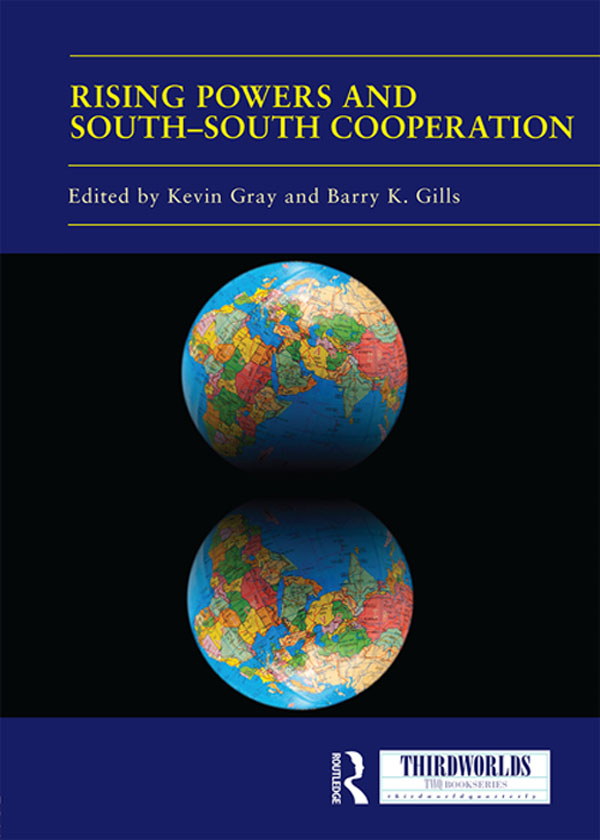
Rising Powers and South-South Cooperation This book examines the extent to which a space has opened up in recent years for the so-called "rising powers" of the global South to offer an alternative to contemporary global economic and political governance through emergent forms of South-South cooperation. In contrast to the Third Worldism of the past, the contemporary rising powers share in common the fact that their recent growth owes much to their extensive and increasingly international engagement, rather than partial withdrawal from the global economy. However, they are nonetheless openly critical of the perceived bias towards the global North in the dominant institutions of global governance, and seek to alter the global status quo to enhance the influence of the global South. Contributions to this volume address the question of whether such engagement, particularly on a "South-South" basis, can be categorised as a "win-win" relationship, or whether we are already seeing the emergence of new forms of competitive rivalry and neo-dependency in action. What kind of theoretical approaches and conceptual tools do we need to best answer such questions? To what extent do new groupings such as BRICS suggest a real alternative to the dominance of the West and of the neoliberal economic globalization paradigm? What possible alternatives exist within contemporary forms of South-South cooperation? This book was originally published as a special edition of Third World Quarterly. POLITICAL SCIENCE,General
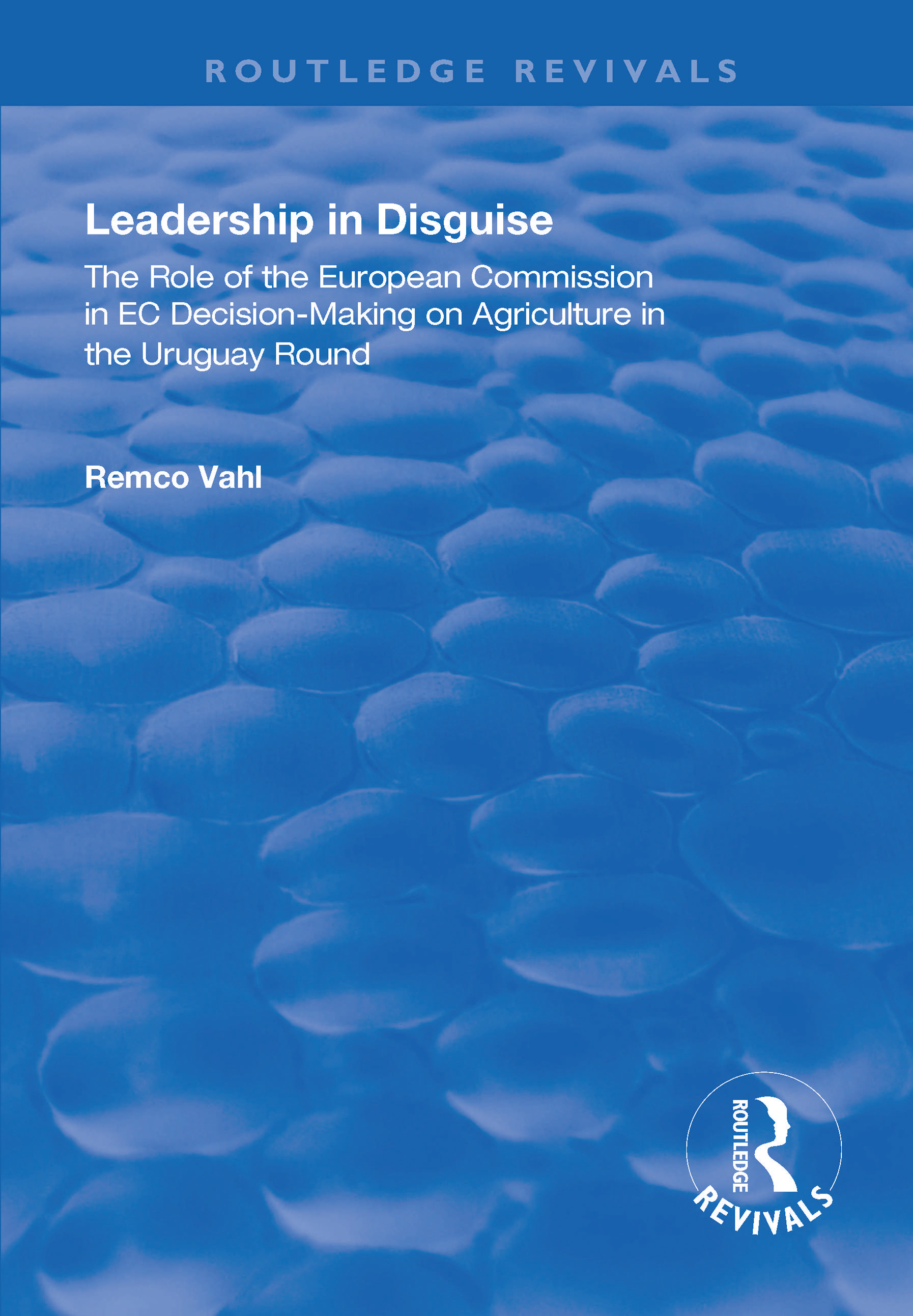
Leadership in Disguise First published in 1997, this volume is situated within a general discussion in which the European Commission is the subject of much myth and speculation. While the political debate on its role in EC decision-making continues, there is still little consensus among academics on the basic nature of the institution – is the Commission an independent, supranational body, or is it dominated by intergovernmental influences? Leadership in Disguise enters this general discussion by providing an original empirical analysis of the Commission’s role during the Uruguay Round of trade negotiations (1986-93). Focusing on the controversial agricultural issue, the book sets out to discover how decisions were made within the European Community. This is a systematic and thorough study of how the Commission can play a leading role in Community decision-making, and will appeal to policy-makers, students and all those seeking an insight into the Commission’s role and EC decision-making. POLITICAL SCIENCE,General
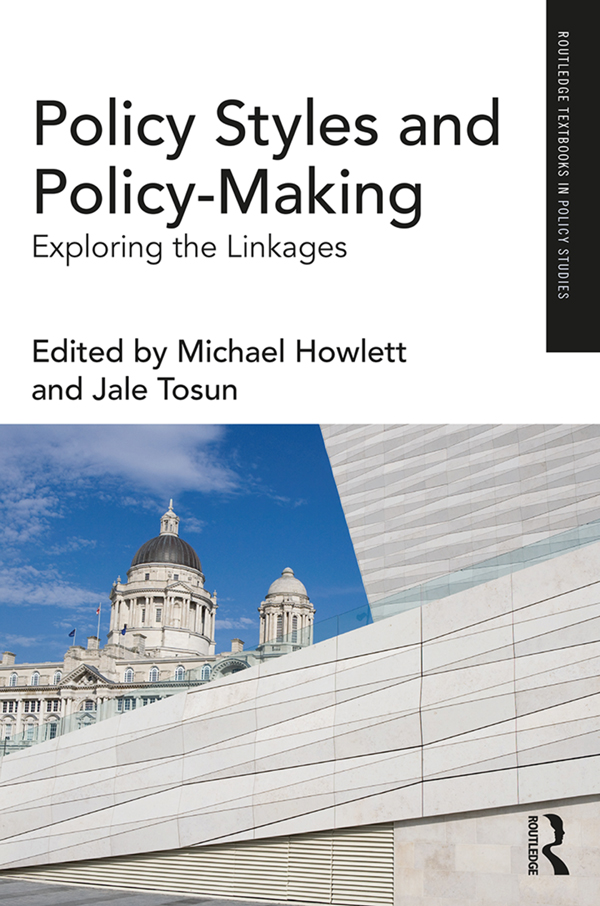
Policy Styles and Policy-Making Richardson et al.’s respected and seminal Policy Styles in Western Europe (1982) shed valuable light on how countries tend to establish long-term and distinctive ways to make policies that transcend short-term imperatives and issues. This follow-up volume updates those arguments and significantly expands the coverage, consisting of 16 carefully selected country-level case studies from around the world. Furthermore, it includes different types of political regimes and developmental levels to test more widely the robustness of the patterns and variables highlighted in the original book. The case studies – covering countries from the United States, Canada, Germany and the UK to Russia, Togo and Vietnam – follow a uniform structure, combining theoretical considerations and the presentation of empirical material to reveal how the distinct cultural and institutional features of modern states continue to have implications for the making and implementation of public policy decisions within them. The book is essential reading for students and scholars of public policy, public administration, comparative politics and development studies. POLITICAL SCIENCE,General
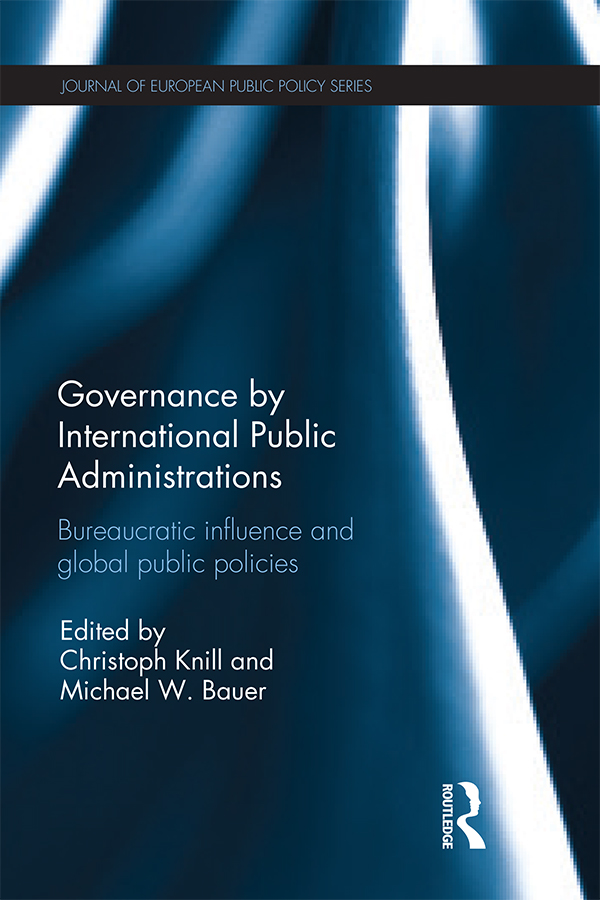
Governance by International Public Administrations As the demand and necessity for greater international and transnational cooperation increase, the bureaucratic bodies of international organizations are receiving ever more scholarly attention. However, the relevance of International Public Administrations (IPAs) for global policy-making remains neither empirically nor theoretically well understood, and yet little systematic knowledge is available about the influence international bureaucracies may have on policy-making. What makes international bureaucracies influential? Are the sources of their influence on policy-making comparable to that of national public administrations? Is there a need to reflect on other factors than known from the analysis of national bureaucracies or for re-assessing the impact of traditional factors of influence in multilevel constellations? Is there a systematic link between intra-organizational structures and the behavior of the personnel of international bureaucracies and the policy output of their organizations? What are the effects of international bureaucracies’ role for particular policies or policy constellations? The different contributions in this volume address these questions from different conceptual perspectives and focus on different tools of administrative governance. This book was originally published as a special issue of the Journal of European Public Policy. POLITICAL SCIENCE,General
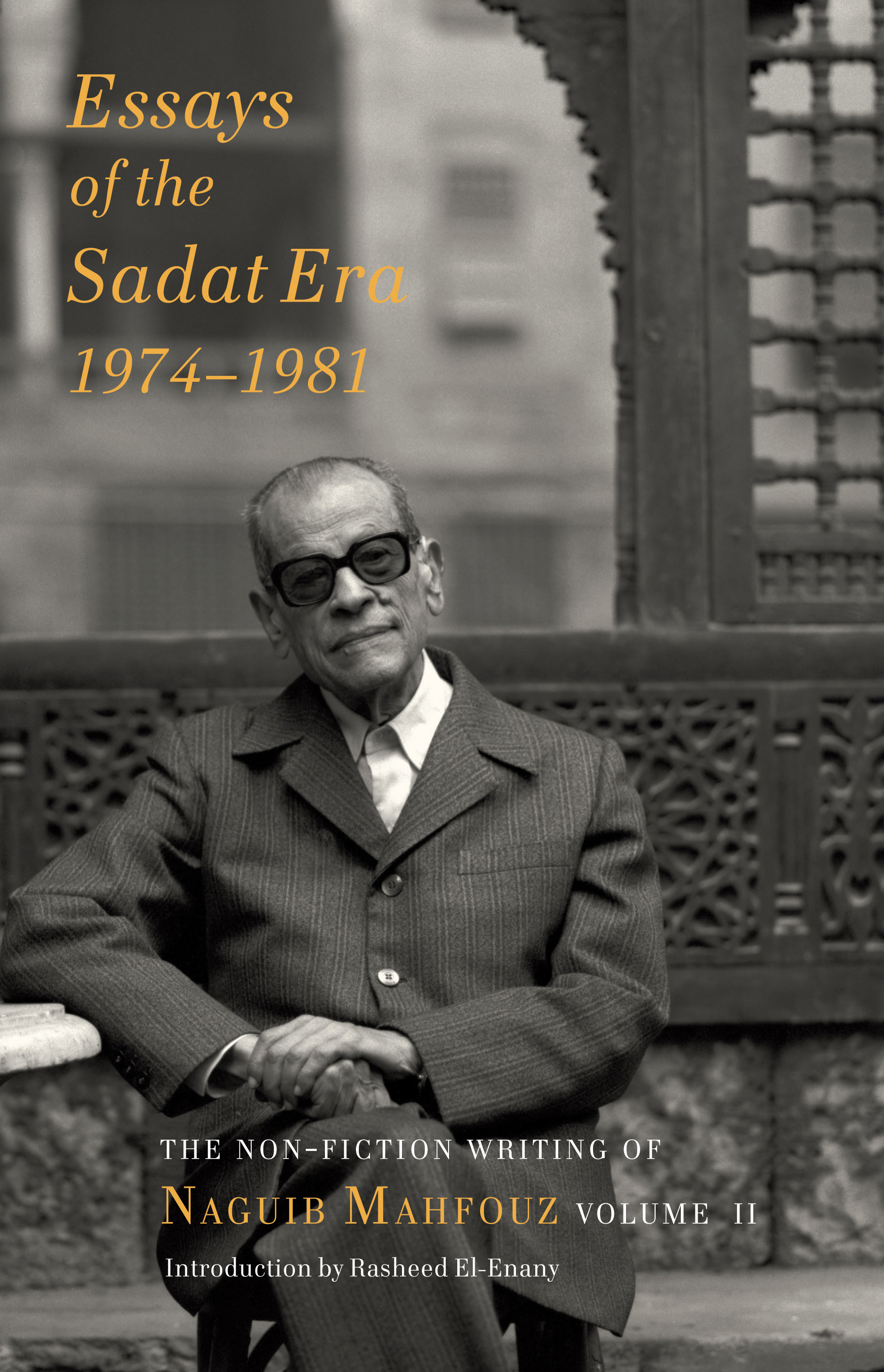
Essays of the Sadat Era When Naguib Mahfouz quit his job as a civil servant in 1971, a Nobel Prize in literature was still off on the horizon, as was his global recognition as the central figure of Arab literature. He was just beginning his post on the editorial staff of the Egyptian newspaper Al-Ahram, and elsewhere in Cairo, Anwar Sadat was just beginning his hugely transformative Egyptian presidency, which would span eleven years and come to be known as the Sadat era. This book offers English-language readers the first glimpse of the Sadat era through Mahfouz’s eyes, a collection of pieces that captures one of Egypt’s most important decades in the prose of one of the Middle East’s most important writers. This volume stitches together a fascinating and vivid account of the dramatic events of Sadat’s era, from his break with the Soviet Union to the Yom Kippur War with Israel and eventual peace accord and up to his assassination by Islamic extremists in 1981. Through this tumultuous history, Mahfouz takes on a diverse array of political topics—including socioeconomic stratification, democracy and dictatorship, and Islam and extremism—which are still of crucial relevance to Egypt today. Clear-eyed and direct, the works illuminate Mahfouz’s personal and political convictions that were more often hidden in his novels, enriching his better-known corpus with social, political, and ideological context. These writings are a rare treasure, a story of a time of tremendous social and political change in the Middle East told by one if its most iconic authors. POLITICAL SCIENCE,General
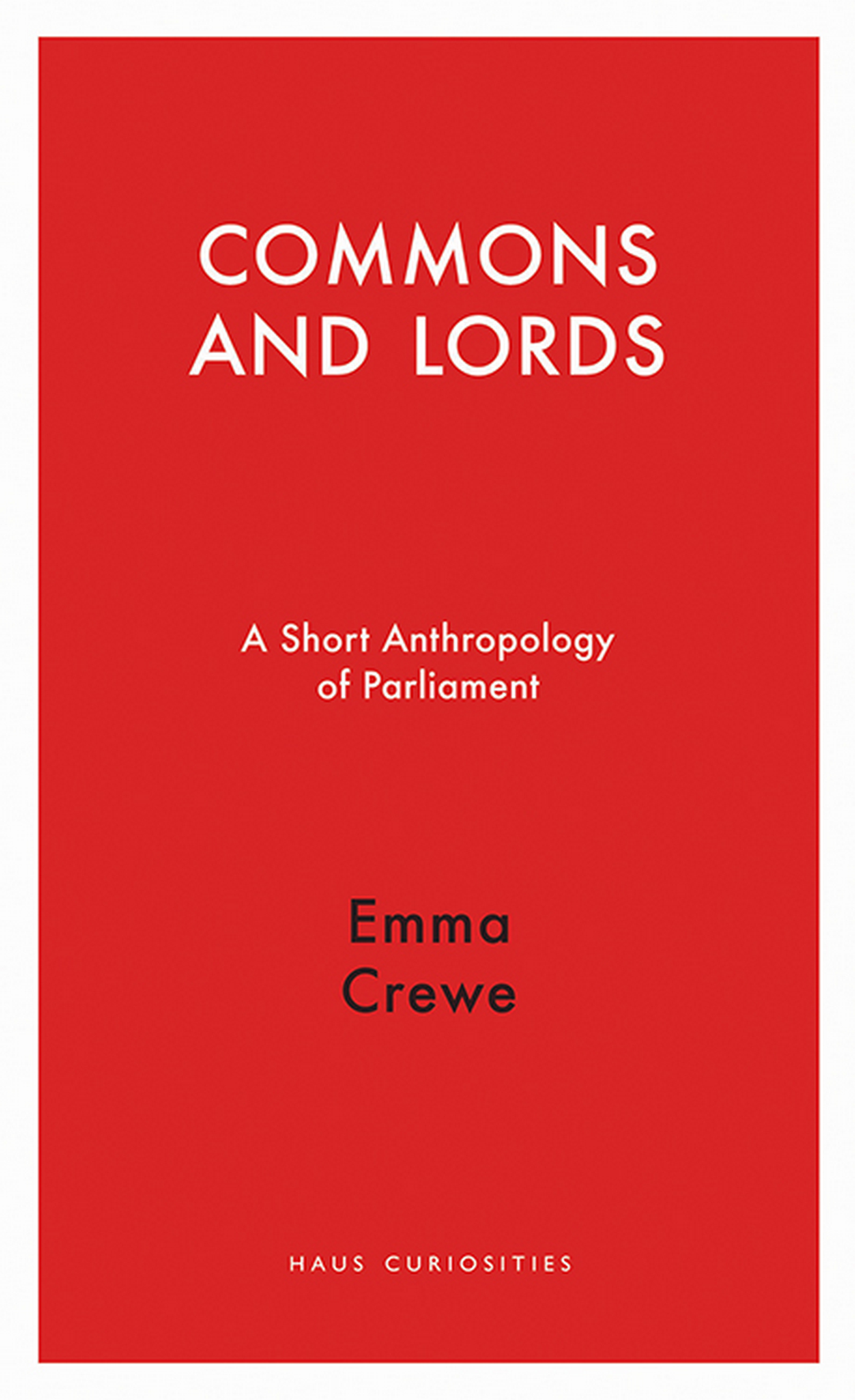
Commons and Lords The British Parliament rewards close scrutiny not just for the sake of democracy, but also because the surprises it contains challenge our understanding of British politics. Commons and Lords pulls back the curtain on both the upper House of Lords and the lower House of Commons to examine their unexpected inner workings. Based on fieldwork within both Houses, this volume in the Haus Curiosities series provides a surprising twist in how relationships in each play out. The high social status of peers in the House of Lords gives the impression of hierarchy and, more specifically, patriarchy. In contrast, the House of Commons conjures impressions of equality and fairness between members. But actual observation reveals the opposite: while the House of Lords has an egalitarian and cooperative ethos that is also supportive of female members, the competitive and aggressive House of Commons is a far less comfortable place for women. Offering many surprises and secrets, this book exposes the sheer oddity of the British parliament system. POLITICAL SCIENCE,General

How Parliament Works Parliament is constantly in the news and televised daily, but much of its work remains a mystery to outsiders and is sometimes perplexing even to its own members. Written by expert insiders, How Parliament Works is a straightforward and readable analysis of one of the country’s most complex – and often misunderstood – institutions. Covering every aspect of the work, membership and structures of both Houses, this key text provides a unique insight into the work and daily life of Parliament. It explains not only what happens but why and analyses the institution’s strengths and weaknesses, as well as opportunities for Parliament to be more effective. The eighth edition has been substantially revised to take account of recent changes in both Houses, and to cover all the key issues affecting Parliament and politics, such as: Parliament, Brexit and Europe – the impact of the referendum vote on Parliament to date, Parliament’s role in implementing Brexit and its role thereafter; Questions about how much Parliament is a genuinely representative body of the population at large in its diversity; The latest developments in the legislative process, party discipline and rebellion; The ‘English votes for English laws’ procedures; The effects of a minority government; Changes to the Budget cycle; Updates on the arrangements for the internal management of both Houses, reflecting governance reviews, with all statistics and examples fully updated throughout. How Parliament Works is essential reading for anyone who has anything to do with the Westminster Parliament: journalists, civil servants, lawyers, lobbyists, business and trade associations, diplomats, overseas parliaments and international bodies – and indeed members of both Houses. How Parliament Works is also an invaluable companion to the study of politics at AS, A2 and university level, and provides a wealth of source material for teachers. POLITICAL SCIENCE,General
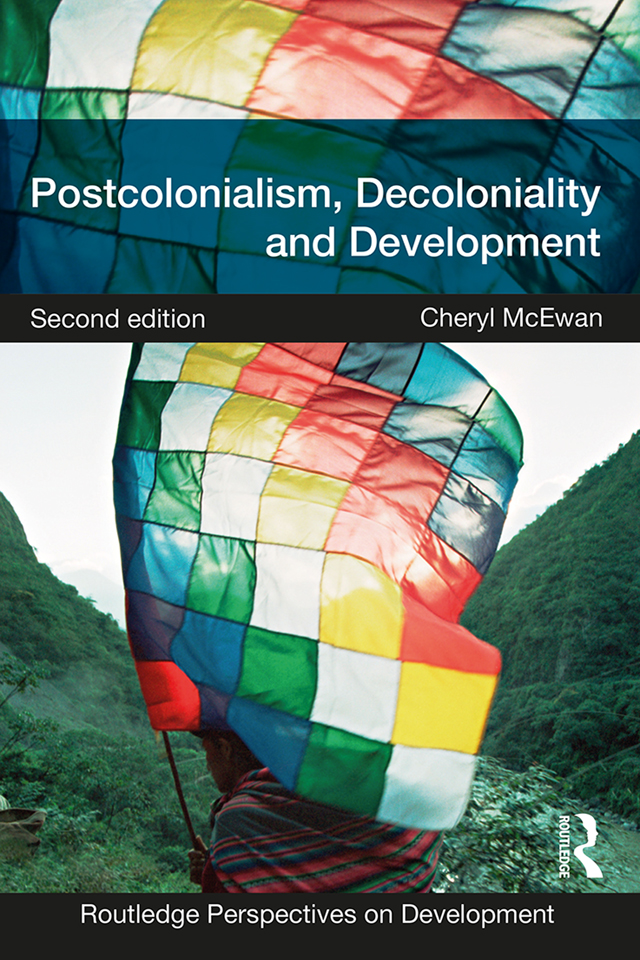
Postcolonialism, Decoloniality and Development Postcolonialism, Decoloniality and Development is a comprehensive revision of Postcolonialism and Development (2009) that explains, reviews and critically evaluates recent debates about postcolonial and decolonial approaches and their implications for development studies. By outlining contemporary theoretical debates and examining their implications for how the developing world is thought about, written about and engaged with in policy terms, this book unpacks the difficult, complex and important aspects of the relationships between postcolonial theory, decoloniality and development studies. The book focuses on the importance of development discourses, the relationship between development knowledge and power, and agency within development. It includes significant new material exploring the significance of postcolonial approaches to understanding development in the context of rapid global change and the dissonances and interconnections between postcolonial theory and decolonial politics. It includes a new chapter on postcolonial theory, development and the Anthropocene that considers the challenges posed by the current global environmental crisis to both postcolonial theory and ideas of development. The book sets out an original and timely agenda for exploring the intersections between postcolonialism, decolonialism and development and provides an outline for a coherent and reinvigorated project of postcolonial development studies. Engaging with new and emerging debates in the fields of postcolonialism and development, and illustrating these through current issues, the book continues to set agendas for diverse scholars working in the fields of development studies, geography, anthropology, politics, cultural studies and history. POLITICAL SCIENCE,General

Home Truths Housing is increasingly unaffordable in many parts of the UK, with prices and rents rising much faster than earnings because, over many decades, far too few homes have been built. Since the 2008 financial crisis, the homes shortage has become more acute – sending housing affordability to the top of the political agenda. Combining analysis with reportage, Home Truths draws on extensive interviews with cabinet ministers, civil servants, planning officials, leading property executives and priced-out homebuyers from across the country. Informed by deep economic research and political access at the highest level, the book is a no-holds-barred critique of the UK’s chronic housing shortage, concluding with eye-catching policy proposals of direct relevance to both Parliament and regional and national government. POLITICAL SCIENCE,General

The American Anomaly The American Anomaly systematically analyzes the U.S. political system by way of comparison with other countries, especially other industrialized democracies. It is organized into four sections, respectively covering the constitutional order, governmental institutions, political participation, and public policy. Extended case studies and examples in each chapter draw on all the major regions of the world. Thoroughly revised throughout, the fourth edition includes: Updates to reflect events including the anomalous presidential election of 2016, the start of the unconventional presidency of Donald Trump, and shifting partisan dynamics within Congress. Coverage of recent political developments such as the Black Lives Matter and Antifa left-wing groups, the rise of the Alt-Right and resurgent nationalism, and youth-led movements for immigration reform and gun violence prevention. A newly developed chapter offering a comparative perspective on U.S. public opinion and mass media, including social media; includes a new case study focused on post-Communist Russia and a chart on comparative freedom of the press. The contextualizing of emerging political memes such as "fake news," "alternative facts," the "deep state," "Brexit," and "#MeToo". Updates to examples from other countries, including challenges to the European Union; the aftermath of the Arab Uprisings; recent political upheavals in Venezuela, Zimbabwe, South Korea, and Brazil; the global reassertion of Russian power and its possible manipulation of the US election; and the steady growth of China’s global military and economic role. A substantive update to the domestic policy chapter, in light of the return of unified Republican control in Washington DC, and to the foreign policy chapter, taking into account isolationist and unlateralist thinking in the Trump administration. Updated tables and charts comparing major democratic political systems; expanded further reading suggestions; and revised discussion questions and Web-based exercises throughout the book. POLITICAL SCIENCE,General
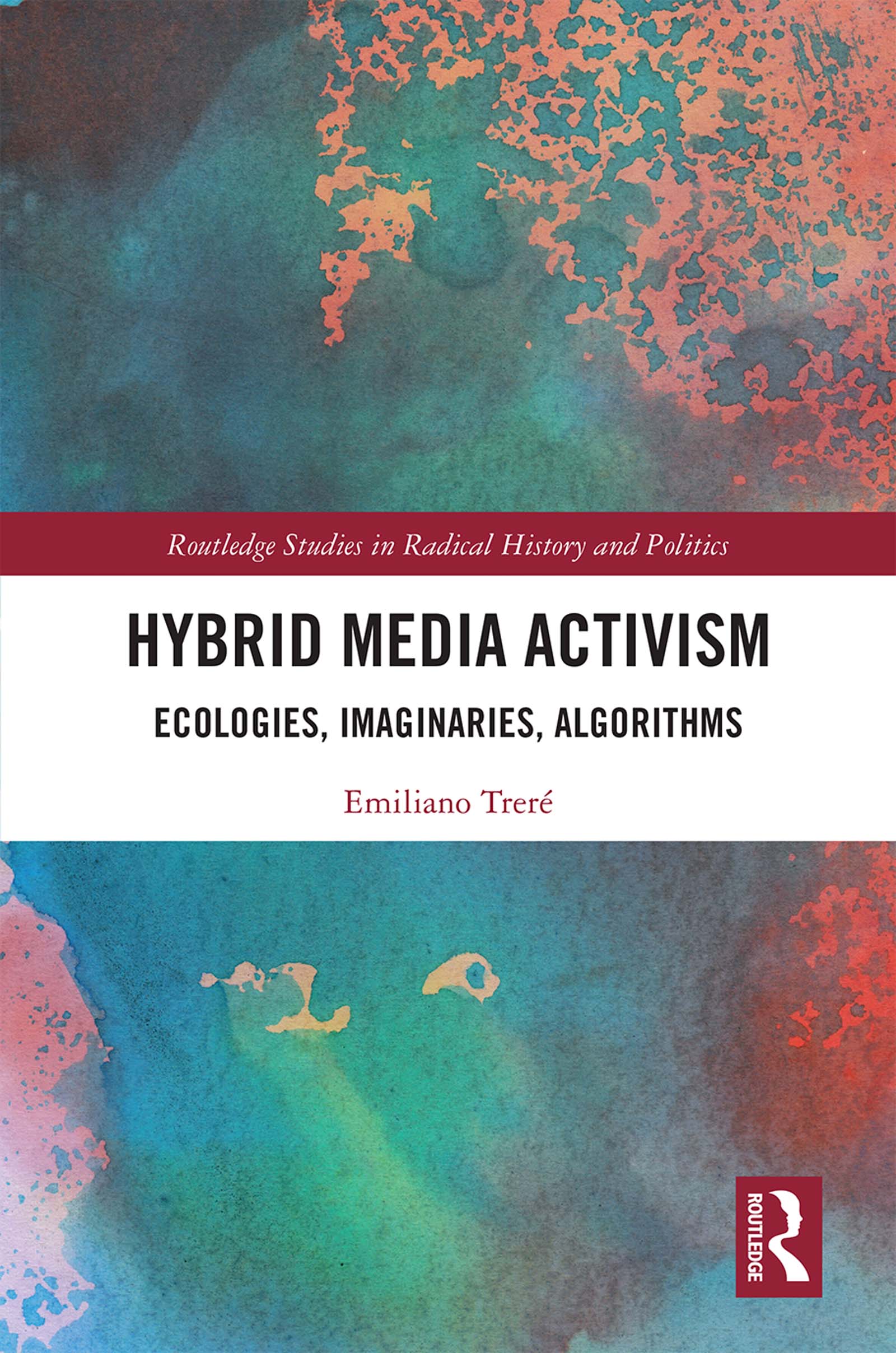
Hybrid Media Activism This book is an extensive investigation of the complexities, ambiguities and shortcomings of contemporary digital activism. The author deconstructs the reductionism of the literature on social movements and communication, proposing a new conceptual vocabulary based on practices, ecologies, imaginaries and algorithms to account for the communicative complexity of protest movements. Drawing on extensive fieldwork on social movements, collectives and political parties in Spain, Italy and Mexico, this book disentangles the hybrid nature of contemporary activism. It shows how activists operate merging the physical and the digital, the human and the non-human, the old and the new, the internal and the external, the corporate and the alternative. The author illustrates the ambivalent character of contemporary digital activism, demonstrating that media imaginaries can be either used to conceal authoritarianism, or to reimagine democracy. The book looks at both side of algorithmic power, shedding light on strategies of repression and propaganda, and scrutinizing manifestations of algorithms as appropriation and resistance. The author analyses the way in which digital activism is not an immediate solution to intricate political problems, and argues that it can only be effective when a set of favourable social, political, and cultural conditions align. Assessing whether digital activism can generate and sustain long-term processes of social and political change, this book will be of interest to students and scholars researching radical politics, social movements, digital activism, political participation and current affairs more generally. POLITICAL SCIENCE,General

Analyzing American Democracy This is an introductory American politics text covering the constitutional framework of American government, political behavior and informal institutions, the formal institutions of American government, and a concluding chapter on public policy. Every chapter highlights the most current thinking in political science research and discusses related public policy. This text teaches students to think analytically by presenting current political science theories and research in answering the engaging, big questions facing American politics today. It serves as an introduction to the discipline by reflecting the theoretical developments and types of empirical inquiry conducted by researchers. New to the Third Edition: 2016 and 2018 election updates and analysis of their political and policy impact Social media’s growing influence on politics The impact of the alt-right and rising populism on elections and policy New trends in public opinion Weakening of the Voting Rights Act Campaign finance upheaval The changing congressional landscape Updated tables, figures, and photos present the empirical details of American politics, helping students gain quantitative literacy Landmark court cases, now highlighted and linked to key concepts Refreshed feature boxes reinforce the book’s dedication to helping students understand the scientific approach to politics, incorporating intriguing new topics including genetics and public opinion, the biology of political participation, and evolution and the bureaucracy POLITICAL SCIENCE,General

Impossible Knowledge Conspiracy theorists claim impossible knowledge, such as knowledge of the doings of a secret world government. Yet they accept this impossible knowledge as truth. In effect, conspiracy theories detach truth from knowledge. Knowledge without power is powerless. And the impossible knowledge claimed by conspiracy theorists is rigorously excluded from the regimes of truth and power – that is not even wrong. Yet conspiratorial knowledge is potent enough to be studied by researchers and recognized as a risk by experts and authorities. Therefore, in order to understand conspiracy theories, we need to think of truth beyond knowledge and power. That is impossible for any scientific discipline because it takes for granted that truth comes from knowledge and that truth is powerful enough to destroy the legitimacy of any authority that would dare to conceal or manipulate it. Since science is unable to make sense of conspiracy theories, it treats conspiracy theorists as individuals who fail to make sense, and it explains their persistent nonsense by some cognitive, behavioral, or social dysfunction. Fortunately, critical theory has developed tools able to conceive of truth beyond knowledge and power, and hence to make sense of conspiracy theories. This book organizes them into a toolbox which will enable students and researchers to analyze conspiracy theories as practices of the self geared at self-empowerment, a sort of political self-help. POLITICAL SCIENCE,General
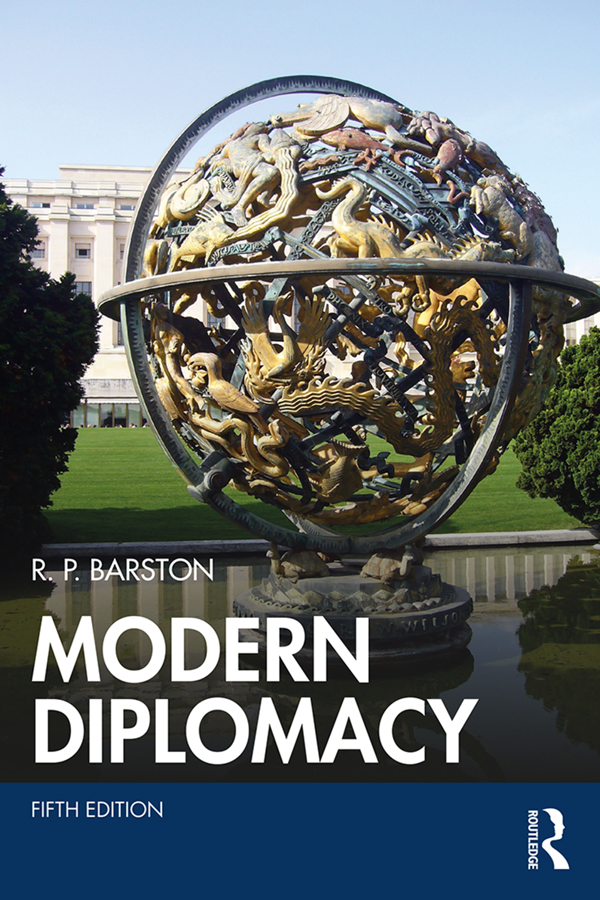
Modern Diplomacy Contemporary, thoughtful and extensively illustrated, Modern Diplomacy examines a broad range of current diplomatic practice. This leading and widely used book - now in its fifth edition - equips students with a detailed analysis of important international issues that reflect and impact upon diplomacy and its relations. The subject is brought to life through case studies and examples which highlight the working of contemporary diplomacy within the international political arena. Organised around five broad topic areas, including the nature of diplomacy, diplomatic methods, negotiation, the operation of diplomacy in specific areas and international conflict, the book covers all major topic areas of contemporary diplomacy. New features for this edition: Developments in diplomatic practice Strategies in diplomacy International trade, geopolitics and agreements Diplomacy of new regional organisations and groupings Developing country diplomacy Non-traditional diplomacy New concepts – parallel and counter diplomacy New case studies include: the Paris Climate Agreement, Brexit, international finance and trade agreements, and the UN security forces. Modern Diplomacy is essential reading for students and practitioners of international relations, foreign policy, international law, international political economy, international economics, the Foreign Services Institutes and the National Diplomatic Academies. POLITICAL SCIENCE,General

Global Politics The third edition of Global Politics: A New Introduction continues to provide a completely original way of teaching and learning about world politics. The book engages directly with the issues in global politics that students are most interested in, helping them to understand the key questions and theories and also to develop a critical and inquiring perspective. Completely revised and updated throughout, the third edition offers up-to-date examples engaging with the latest developments in global politics, including the Syrian war and the refugee crisis, fossil fuel divestment, racism and Black Lives Matter, citizen journalism, populism, and drone warfare. Global Politics: examines the most significant issues in global politics – from war, peacebuilding, terrorism, security, violence, nationalism and authority to poverty, development, postcolonialism, human rights, gender, inequality, ethnicity and what we can do to change the world; offers chapters written to a common structure, which is ideal for teaching and learning, and features a key question, an illustrative example, general responses and broader issues; integrates theory and practice throughout the text, by presenting theoretical ideas and concepts in conjunction with a global range of historical and contemporary case studies. Drawing on theoretical perspectives from a broad range of disciplines, including international relations, political theory, postcolonial studies, sociology, geography, peace studies and development, this innovative textbook is essential reading for all students of global politics and international relations. POLITICAL SCIENCE,General
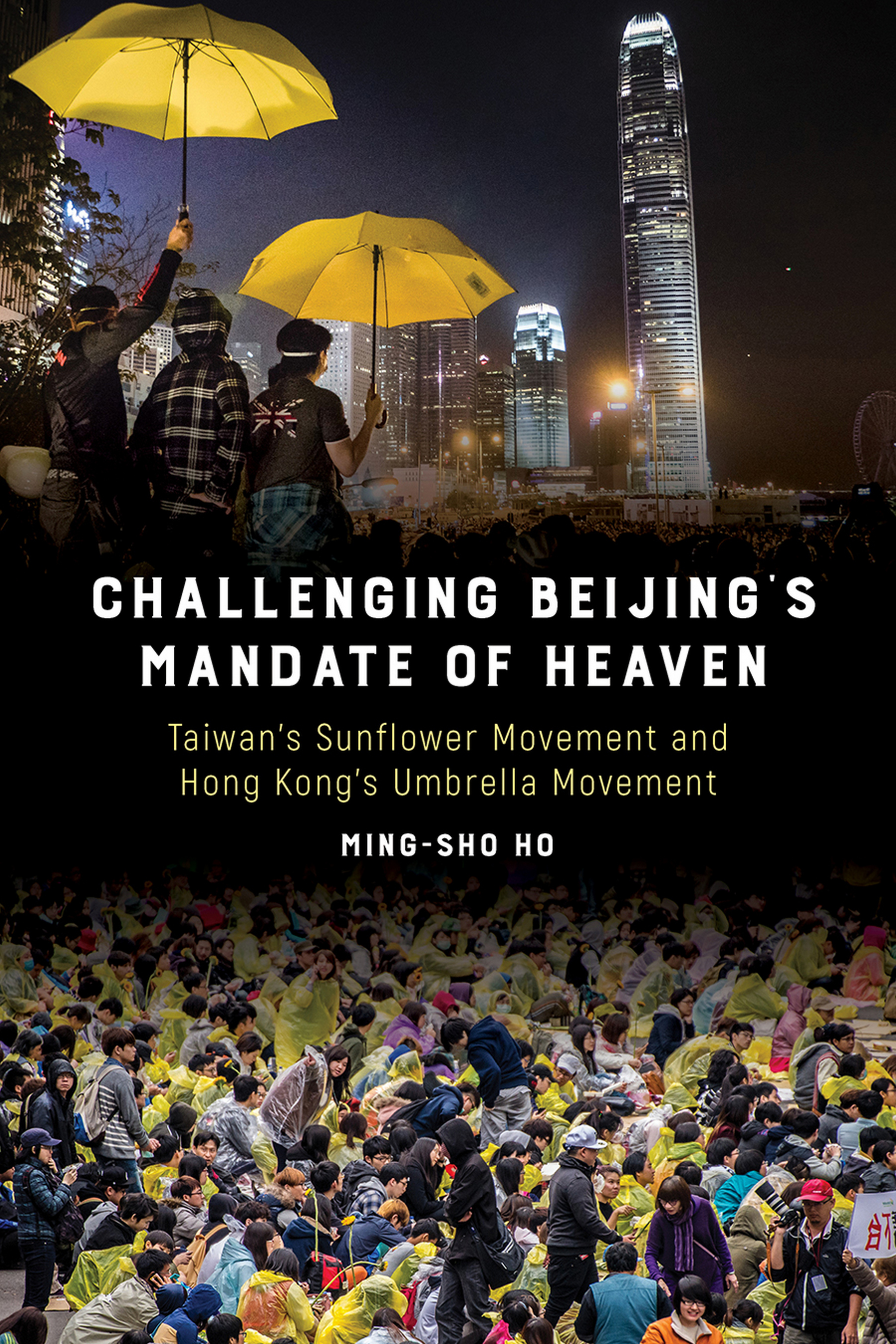
Challenging Beijing's Mandate of Heaven In 2014, the Sunflower Movement in Taiwan grabbed international attention as citizen protesters demanded the Taiwan government withdraw its free-trade agreement with China. In that same year, in Hong Kong, the Umbrella Movement sustained 79 days of demonstrations, protests that demanded genuine universal suffrage in electing Hong Kong’s chief executive. It too, became an international incident before it collapsed. Both of these student-led movements featured large-scale and intense participation and had deep and far-reaching consequences. But how did two massive and disruptive protests take place in culturally conservative societies? And how did the two “occupyâ€-style protests against Chinese influences on local politics arrive at such strikingly divergent results? Challenging Beijing’s Mandate of Heaven aims to make sense of the origins, processes, and outcomes of these eventful protests in Taiwan and Hong Kong. Ming-sho Ho compares the dynamics of the two movements, from the existing networks of activists that preceded protest, to the perceived threats that ignited the movements, to the government strategies with which they contended, and to the nature of their coordination. Moreover, he contextualizes these protests in a period of global prominence for student, occupy, and anti-globalization protests and situates them within social movement studies. POLITICAL SCIENCE,General

Plots and Prayers In an enthralling sequel to her bestselling The Road to Ruin, Niki Savva reveals the inside story of a bungled coup that overthrew the Liberal prime minister, Malcolm Turnbull, and installed a surprise successor, Scott Morrison, who went on to take the party to a miraculous electoral victory. On 21 August 2018, 35 Liberal MPs cast their vote against Malcolm Turnbull, effectively signalling the end of his leadership. Three days later, the deed was done, and Scott Morrison was anointed prime minister. Tony Abbott’s relentless campaign of destabilisation, helped along by his acolytes in the parliament and by his powerful media mates, the betrayals of colleagues, and the rise of the religious right — climaxing in Peter Dutton's challenge — all played a part in Turnbull’s downfall. But so did Turnbull’s own poor political judgement. He was a good prime minister and a terrible politician. The good bits of Malcolm were not enough to make up for the bad Malcolm. Nevertheless, the sheer brutality of his removal left many Liberals aghast. MPs were traumatised or humiliated by eight days of madness. Men and women cried from sheer anguish. They went through hell, and feared when it was over that they would not make it back — and nor would the Liberal Party. As it turned out, redemption came with Morrison’s unexpected single-handed 2019 election victory. Turnbull’s road ended in ruins, as it was always bound to and as he always knew it would, as he predicted to Niki Savva less than three years before it happened. But when his end was imminent, he could not bear to let go. And when it was over, he was defiant, fragile — and, yes — vengeful. This is the inside story of what happened — and what happened next. POLITICAL SCIENCE,General

The Essence of Politics ntroduction to political science. Discusses the character of the 'political'; its essential characteristics; key question to address for understanding politics; key concepts such as power, conflict, cooperation, political system and political community.Politics is about the resolution of matters for a society or group that are contested. It exists not only in and between states (with their governments and other political institutions), but also in churches, sports organisations, commercial enterprises, schools and social organisations. Politics is driven by conflict, but also by cooperation. To understand politics requires asking specific ('key') questions about the nature of conflicts; about persons, groups and institutions that are involved; about their resources; and about the wider context that provides constraints and opportunities for all. It Also requires a grasp of key concepts such as power, influence and political community, and, of course, of the term politics, conflict and cooperation. This book is about the 'essence' of politics, which is introduced by way of key questions and key concepts that are indispensable for understanding politics in many different settings. POLITICAL SCIENCE,General
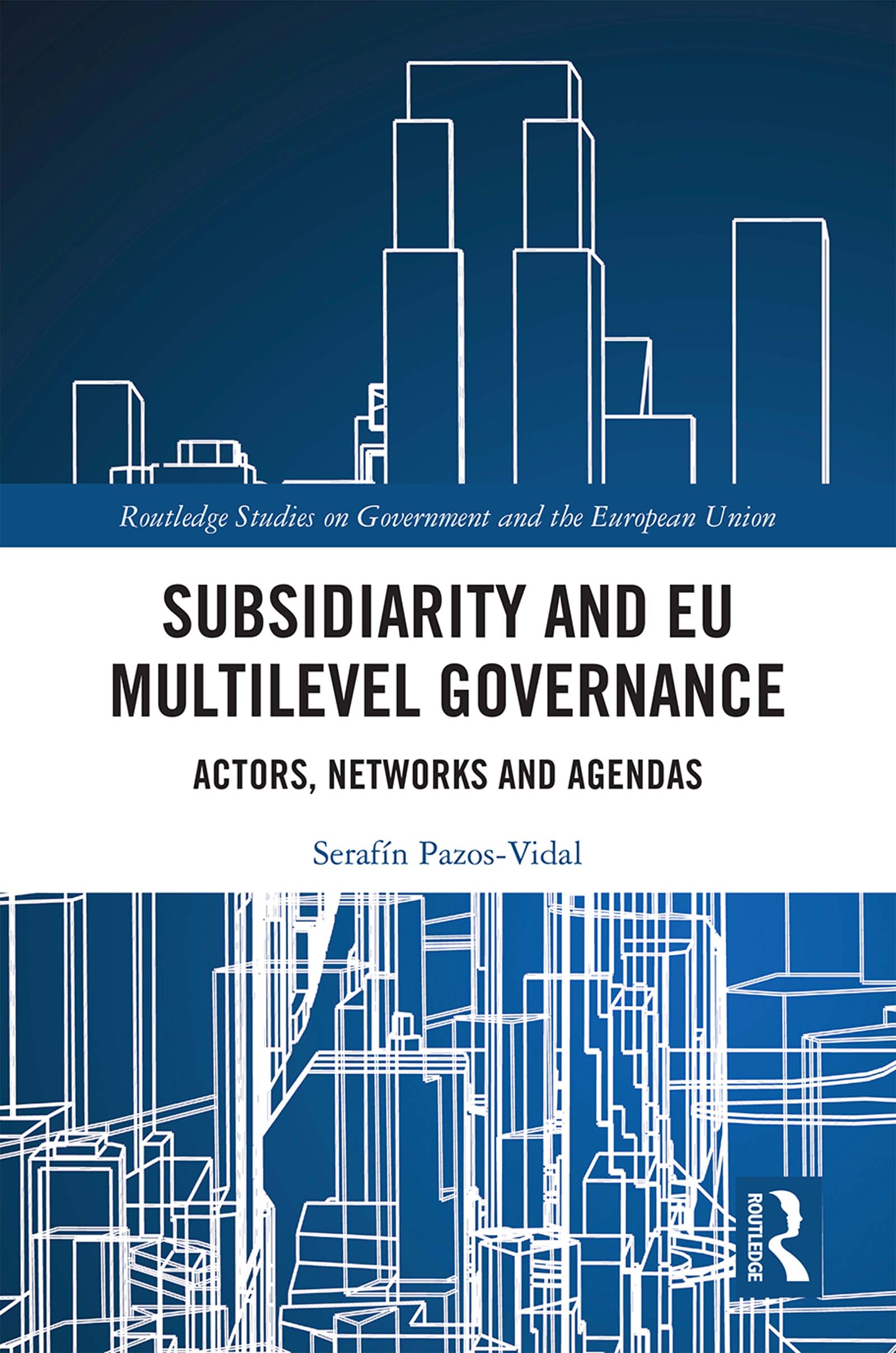
Subsidiarity and EU Multilevel Governance This book examines the theory and praxis of the legal concept of subsidiarity and the policy paradigm of multilevel governance, providing an updated overview on how subnational and national authorities engage within the EU institutional framework. Providing a theoretical assessment of real-life case studies, the book reflects on a number of key events from the negotiations of the European Convention to the process that led to the "Brexit" referendum and assesses the key agendas and institutional ethos of most actors involved in EU policymaking. It particularly focusses on the EU engagement of so-called non-privileged actors, such as subnational authorities from the UK, Germany, Austria, Italy, the Netherlands and Scandinavia, as well as national and regional parliaments. The author goes on to examine the sometimes selfish behaviour and individual agendas of the European Commission, European Parliament, Member States and even the European Court of Justice but also identifies many constructive ways of interaction that can decisively frame how EU decisions are made. This comprehensive book will be a useful reference to students, practitioners and academic researchers working in European politics, policymaking, public policy and EU law and integration. POLITICAL SCIENCE,General
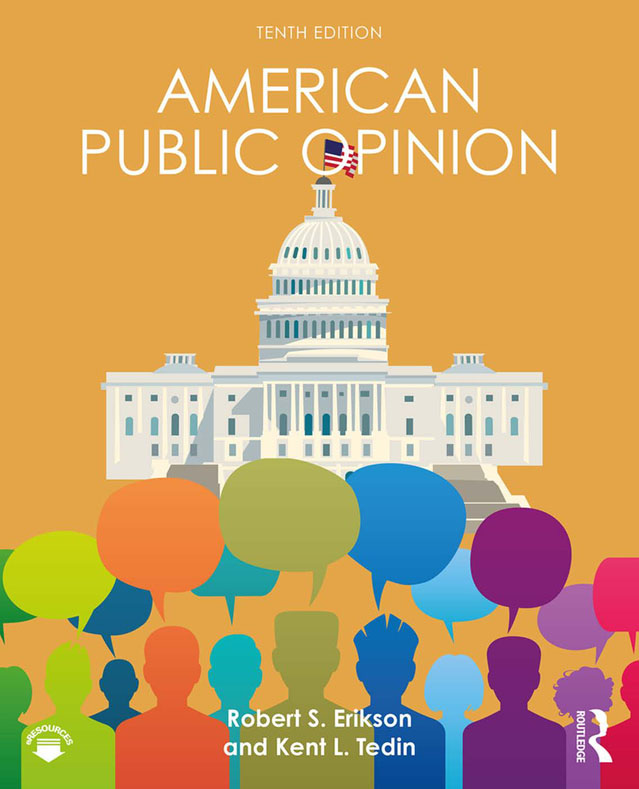
American Public Opinion Providing an in-depth analysis of public opinion, including its origins in political socialization, its role in the electoral process, and the impact of the media, American Public Opinion goes beyond a simple presentation of data to include a critical analysis of the role of public opinion in American democracy. New to the Tenth Edition Updates all data through the 2016 elections and includes early polling through 2018. Pays increased attention to polarization. Adds a new focus on public opinion and immigration. Covers new voting patterns related to race, ethnicity, and gender. Reviews public opinion developments on health care. Expands coverage of political misinformation, media bias, and negativity, especially in social media. Defends political polling even in the wake of 2016 failings. POLITICAL SCIENCE,General
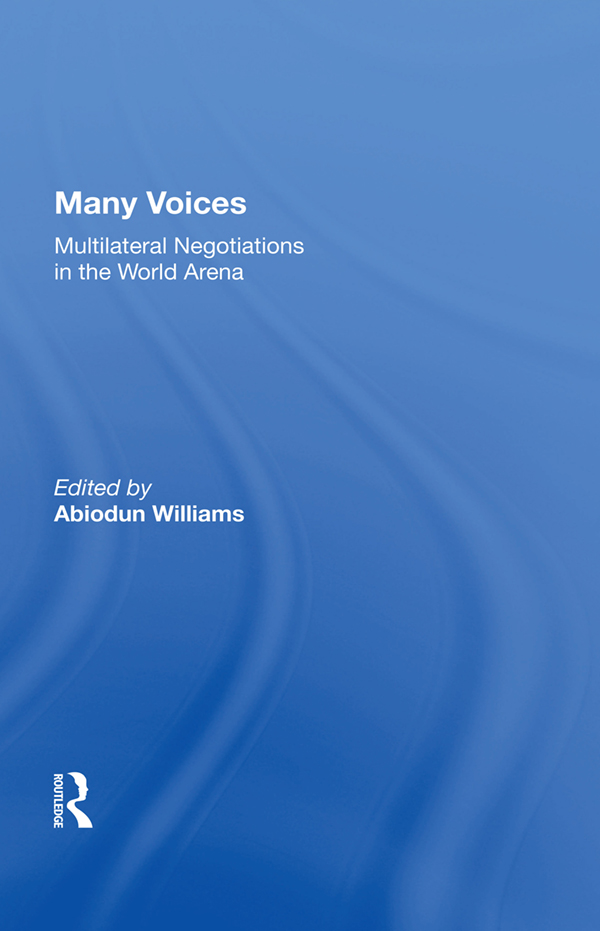
Many Voices International negotiations increasingly involve a myriad of state and nonstate actors who approach major issues from a variety of standpoints and work to determine outcomes acceptable to all. Great powers, military allies, business and industry, LDCs, international organizations, and even domestic politics enter into negotiations on complex issues-ranging from defense and national security to environmental protection and Third World development-that now dominate the global agenda. Abiodun Williams has assembled a collection of case studies that illustrate the variety and dynamism of this complex decisionmaking process. Cases including conflict resolution in Indochina and mining in Antarctica show students the role of contending national objectives, necessary trade-offs, and efforts at coalition building, as well as the influence of personality and persuasion on the outcomes of major negotiations. A case exploring the investment activities of transnational corporations and their impact on developing countries is organized as a simulation exercise that offers students rare insight into negotiations under UN auspices and the impact of regional bloc politics on multilateral diplomacy. POLITICAL SCIENCE,General

An Heretical Heir Of The Enlightenment This is primarily, but not exclusively, a book on Lindblom. All the pieces in it bear on his work, either as direct commentary on it or criticism of it, or as extensions of his ideas. But at the same time every piece follows the trajectory of its own ideas into the subject matter in which it delves. And these subjects are many and varied. Indeed, the prime purpose of this volume is to make the broad public aware of the full scope and amplitude of Lindblom' s thought and to convey something of the inner coherence that governs it. Anyone who has previously encountered Lindblom only in one manifestation of his multifaceted mind might be surprised to learn that there are so many other facets as well. Merely to list the disciplines to which he has contributed threatens to extend into an academic catalogue of ships. But the truth is that his work is not docilely academic, it refuses to lie down neatly and supinely into the procrustean beds of the established disciplines. Like his closest predecessor, Veblen, he offers a comprehensive treatment of social reality as a whole -- together with something of the same heretical thrust against the academic establishment. POLITICAL SCIENCE,General
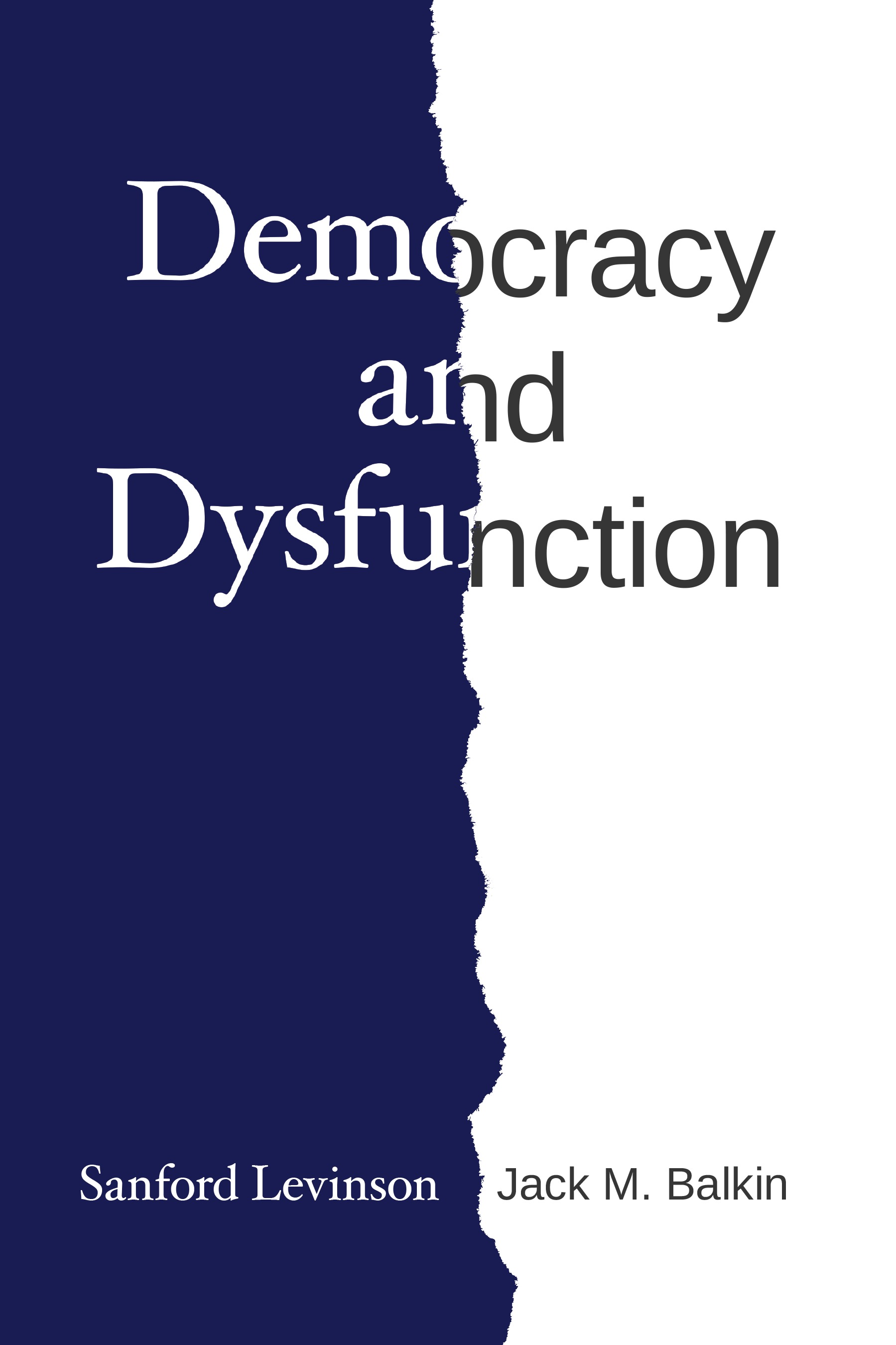
Democracy and Dysfunction It is no longer controversial that the American political system has become deeply dysfunctional. Today, only slightly more than a quarter of Americans believe the country is heading in the right direction, while sixty-three percent believe we are on a downward slope. The top twenty words used to describe the past year include “chaotic,†“turbulent,†and “disastrous.†Donald Trump’s improbable rise to power and his 2016 Electoral College victory placed America’s political dysfunction in an especially troubling light, but given the extreme polarization of contemporary politics, the outlook would have been grim even if Hillary Clinton had won. The greatest upset in American presidential history is only a symptom of deeper problems of political culture and constitutional design. Democracy and Dysfunction brings together two of the leading constitutional law scholars of our time, Sanford Levinson and Jack M. Balkin, in an urgently needed conversation that seeks to uncover the underlying causes of our current crisis and their meaning for American democracy. In a series of letters exchanged over a period of two years, Levinson and Balkin travel—along with the rest of the country—through the convulsions of the 2016 election and Trump’s first year in office. They disagree about the scope of the crisis and the remedy required. Levinson believes that our Constitution is fundamentally defective and argues for a new constitutional convention, while Balkin, who believes we are suffering from constitutional rot, argues that there are less radical solutions. As it becomes dangerously clear that Americans—and the world—will be living with the consequences of this pivotal period for many years to come, it is imperative that we understand how we got here—and how we might forestall the next demagogue who will seek to beguile the American public. POLITICAL SCIENCE,General
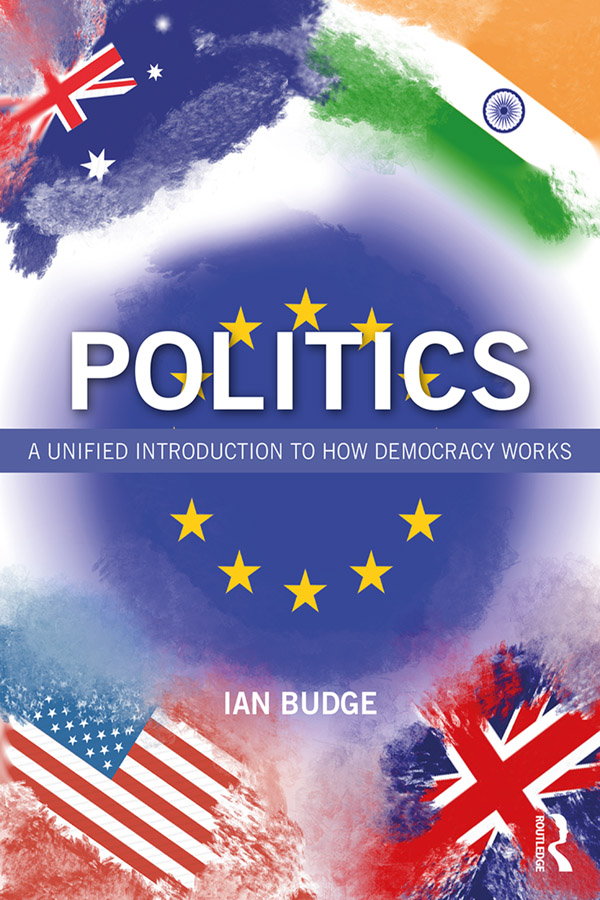
Politics This comprehensive introduction to politics provides an essential template for assessing the health and workings of present day democracy by exploring how democratic processes bring public policy into line with popular preferences. Incorporating the latest findings from Big Data across the world, it provides a crucial framework showing students how to deploy these for themselves, providing straightforward, practical orientation to the scope and methods of modern political science. Key features: Everyday politics is explained through concrete applications to democracies across the world; Predictive theories illuminate what goes on at various levels of democracy; Outlines - in easy to understand terms - the basic statistical approaches that enable empirically-informed analysis; Rich textual features include chapter summaries, reviews, key points, illustrative briefings, key concepts, project and essay suggestions, relevant reading all clearly explained in ‘How to Use This Book’; Provides a firm basis for institutional and normative approaches to democratic politics; Concluding section reviews other approaches to explaining politics, assessing their strengths and weaknesses. Politics is an essential resource for students of political science and of key interest to economics, public policy analysis and more broadly the social sciences. POLITICAL SCIENCE,General
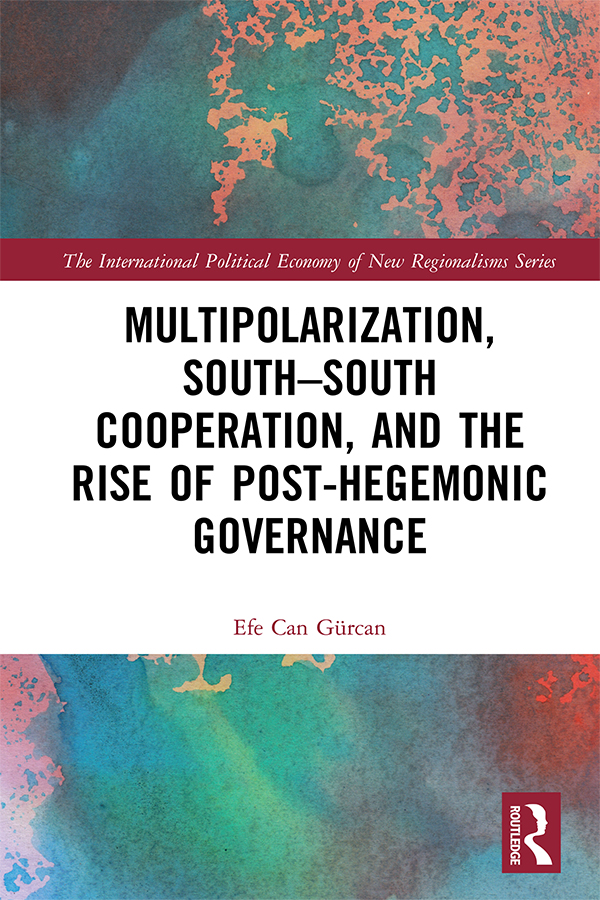
Multipolarization, South-South Cooperation and the Rise of Post-Hegemonic Governance The crisis of Northern capitalism and failure of hegemonic global governance have created a facilitative environment for post-hegemonic initiatives promoting South–South cooperation. Major Southern countries – especially the BRICS – have taken the lead in pushing for alternative governance mechanisms that are strongly articulated in the areas of economic, financial, cultural, and defense cooperation. This book focuses on the historical, political-economic, and geopolitical context in which major Southern countries implement a post-hegemonic agenda. Providing a global and comprehensive perspective through a series of focused case studies from Europe, Latin America, Eurasia, and Africa, the author develops a new approach to the multipolarization of world politics based on "global hegemony". Highly recommended for scholars, students, and activists involved in global political economy, regionalism studies, and international development, this book will be of interest to anyone seeking to develop their understanding of world politics and South–South cooperation. POLITICAL SCIENCE,General
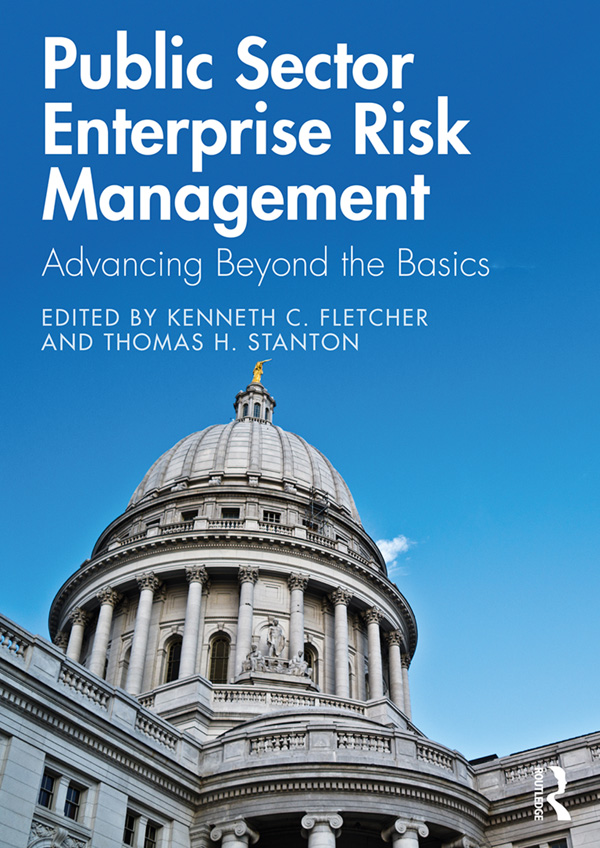
Public Sector Enterprise Risk Management Through a series of case studies and selected special topics, Public Sector Enterprise Risk Management presents examples from leading Enterprise Risk Management (ERM) programs on overcoming bureaucratic obstacles, developing a positive risk culture, and making ERM a valuable part of day-to-day management. Specifically designed to help government risk managers, with concepts and approaches to help them advance risk management beyond the basics, the book: Provides a balanced mix of concepts, instruction and examples; Addresses topics that go beyond the basics of Enterprise Risk Management (ERM) program design and implementation; Includes insights from leading practitioners and other senior officials. Many government organizations can refer to the growing body of materials that provide examples of ERM processes and procedures. Far fewer reference materials and examples exist to help organizations develop a risk-mature organizational culture that is critical to the long-term success and strategic value that ERM represents to government organizations. Public Sector Enterprise Risk Management begins to fill that void and is intended to help public sector risk managers overcome barriers that inhibit ERM from becoming an active contributor to major decisions that top officials must make. POLITICAL SCIENCE,General
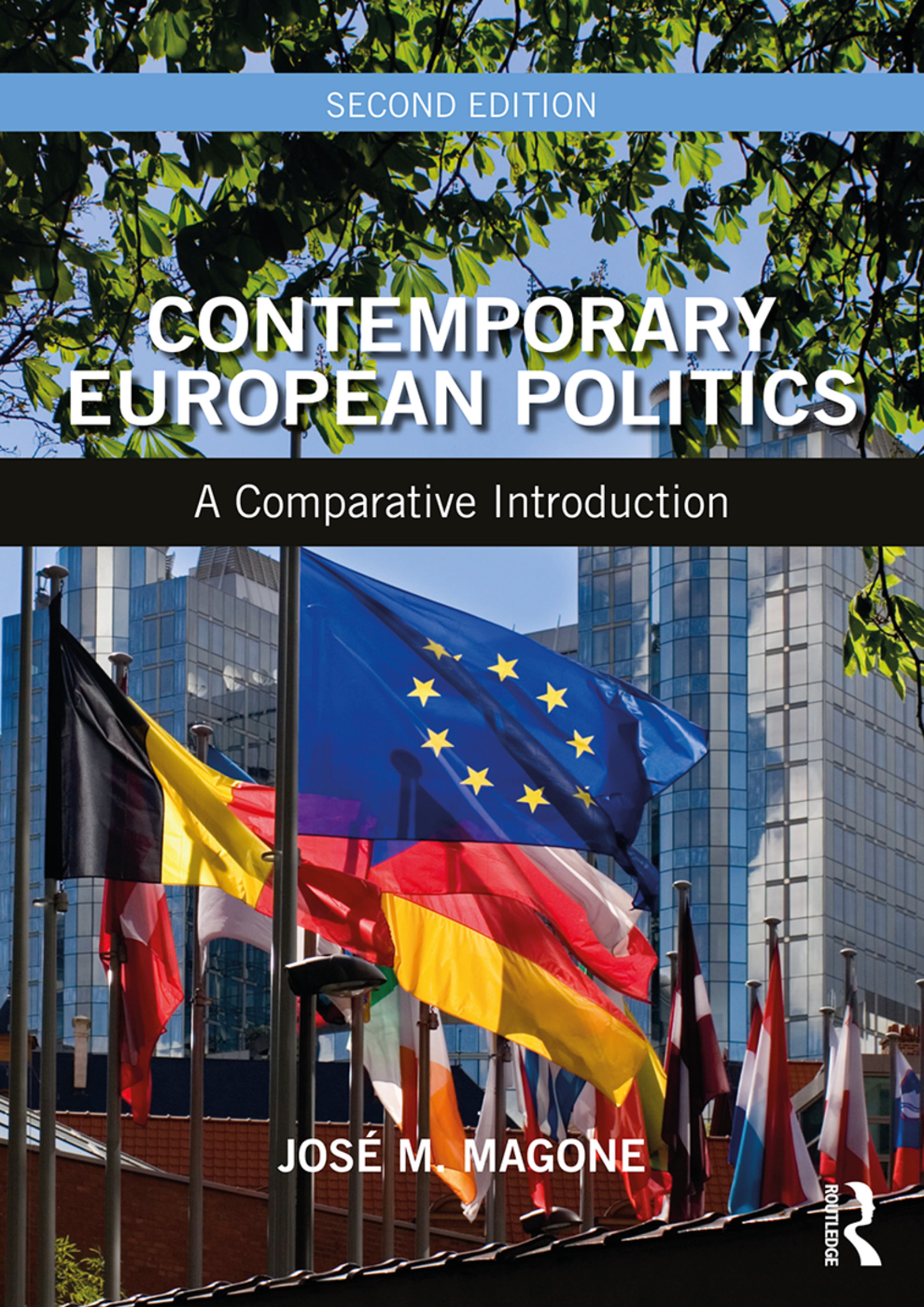
Contemporary European Politics Revised throughout, the second edition of this comprehensive and highly respected textbook continues to provide a thorough introduction to European and European Union politics. Pairing a genuinely comparative approach with in-depth analysis of the national, supranational, local and regional political systems of large and small countries across Europe, including Central and Eastern Europe and the Balkans, this accessible book covers history, theory, institutions, parties and party systems, and interest groups, among others. Key topics and features of this book: Examines the European Union multilevel governance system and uses a regional cluster approach to highlight differences across Europe. Contextualises European politics in a theoretical framework explaining the major political, social and economic transformations taking place in the information age. A new chapter on the comparative political systems and cultures of wider Europe, particularly Russia, Ukraine, Moldova, Georgia, Belarus and Turkey. Engages with the latest challenges and crises facing Europe, including new streamlined chapters on parties, elections, politics and policy-making of the European Union. Extended coverage of hot topics such as finance and the Eurocrisis, immigration, populism and xenophobia. Uses a wide range of pedagogical features including further readings and revision questions. Includes a fully updated companion website containing rich reference data, chapter summaries and weblinks. Richly illustrated throughout, this work is an indispensable resource for all students and scholars of European politics. POLITICAL SCIENCE,General
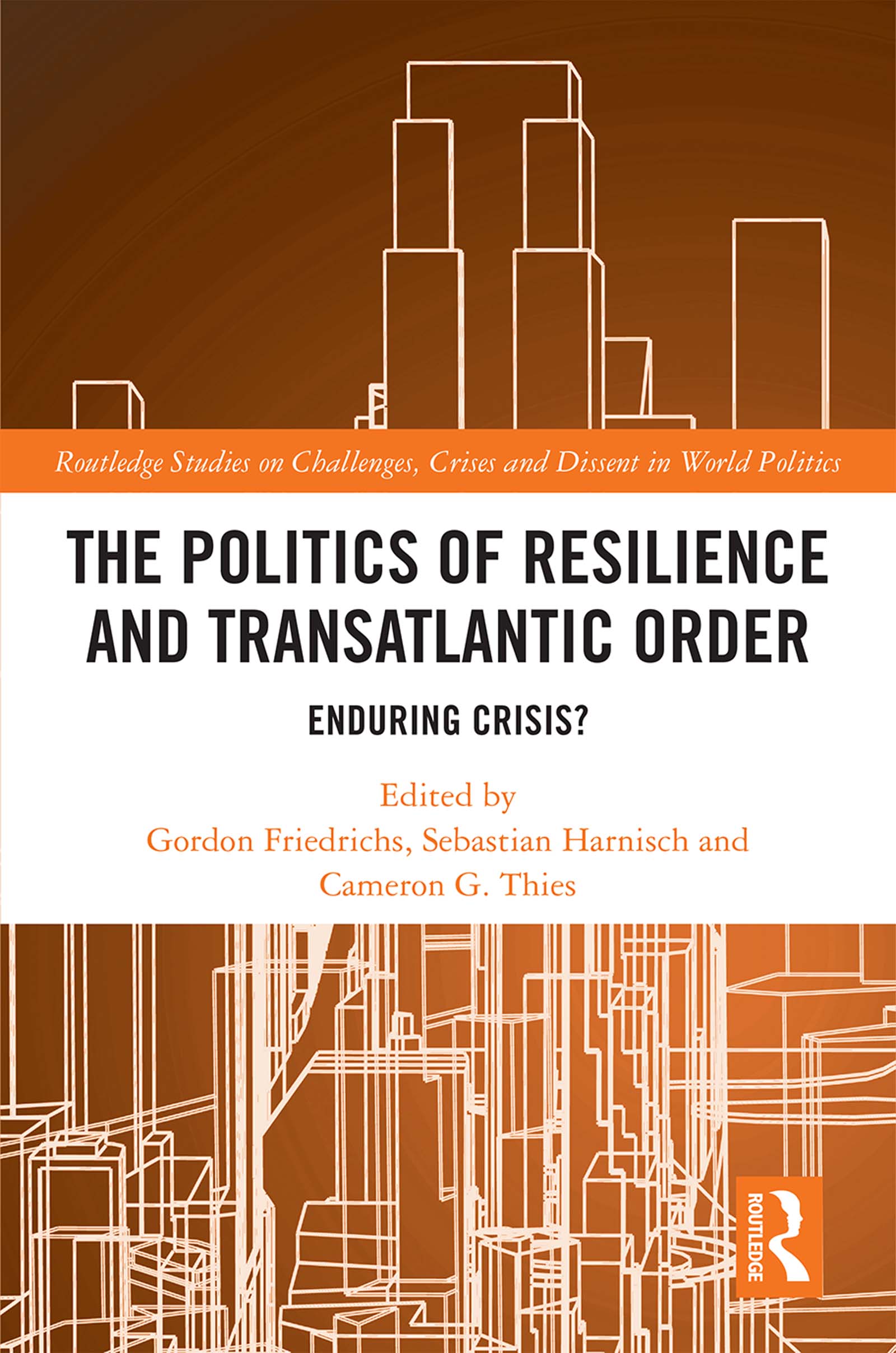
The Politics of Resilience and Transatlantic Order This edited volume bridges the "analytical divide" between studies of transatlantic relations, democratic peace theory, and foreign policy analysis, and improves our theoretical understanding of the logic of crises prevention and resolution. The recent rise of populism and polarization in both the U.S.A and Europe adds to a host of foreign policy crises that have emerged in transatlantic relations over the last two decades. Through examining how democracies can manage to sustain and maintain mechanisms of crisis resilience that are embedded in the democratic peace, and particularly transatlantic relations, this book helps enhance the understanding of inter-democratic crisis resolution across issue areas. In doing so, it addresses some of the most important and prevalent crises of our time, such as anti-terrorism intervention in Afghanistan; Iran’s nuclear program; burden-sharing within North Atlantic Treaty Organization NATO; key aspects of the international order, such as binding norms for cyber security and the integration of China into the Western-led international economic order; as well as domestic order shifts, such as the British vote to leave the European Union (EU) and the impact of the Trump administration populist foreign policy on transatlantic crisis resolution. This book will be of key interest to students and scholars of International Relations, Transatlantic Studies, Foreign Policy Analysis, and Comparative Politics. POLITICAL SCIENCE,General
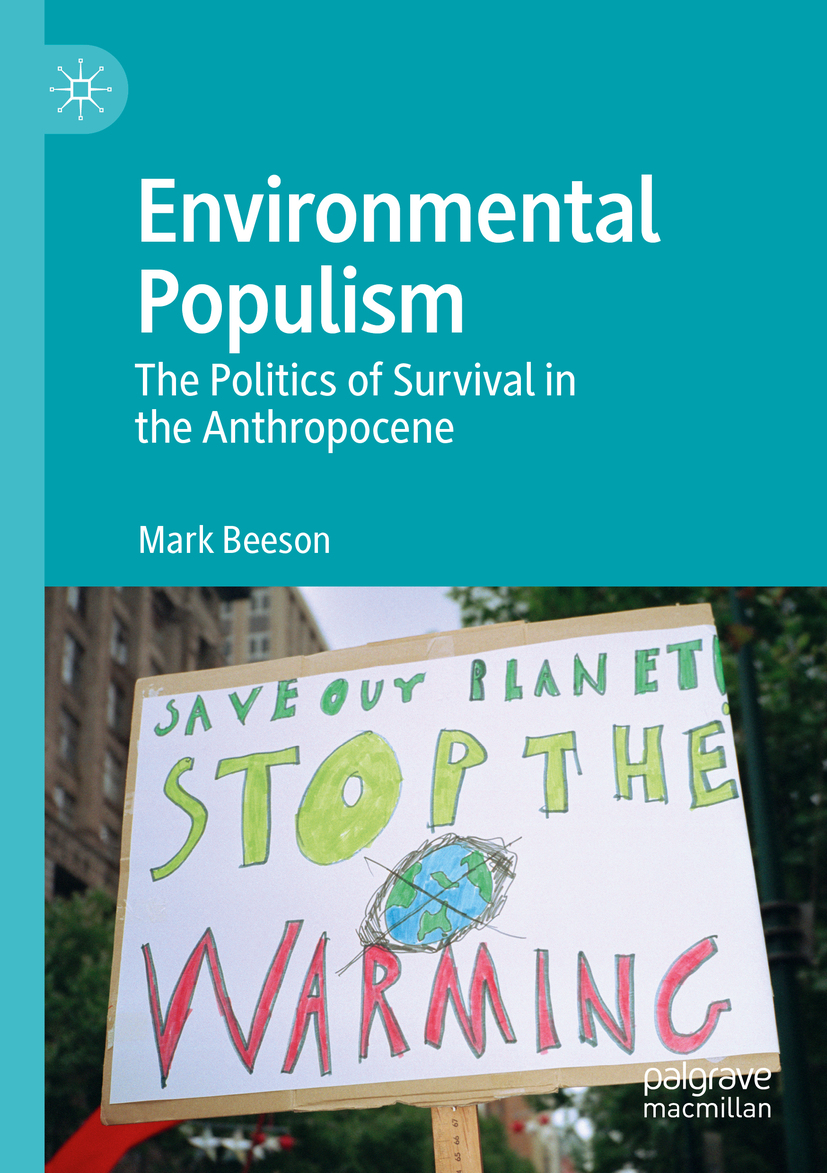
Environmental Populism This book evaluates climate change and populism, two ideas that do not generally go together. The author argues that perhaps they should if policymakers are to be galvanized into action before it is too late. Although populism is usually associated with right-wing authoritarianism, there is growing interest in more progressive forms of populist politics. Across the world, young people in particular are mobilizing to demand change from an older generation that appears to be incapable of action or is hostage to powerful vested interests and outdated ideas. In this book, the author explains why populist forms of political action may yet provide the key to effective policies, which are often discussed but less frequently implemented. Accessible and trenchantly argued, this book presents a primer for the politics of survival. POLITICAL SCIENCE,General
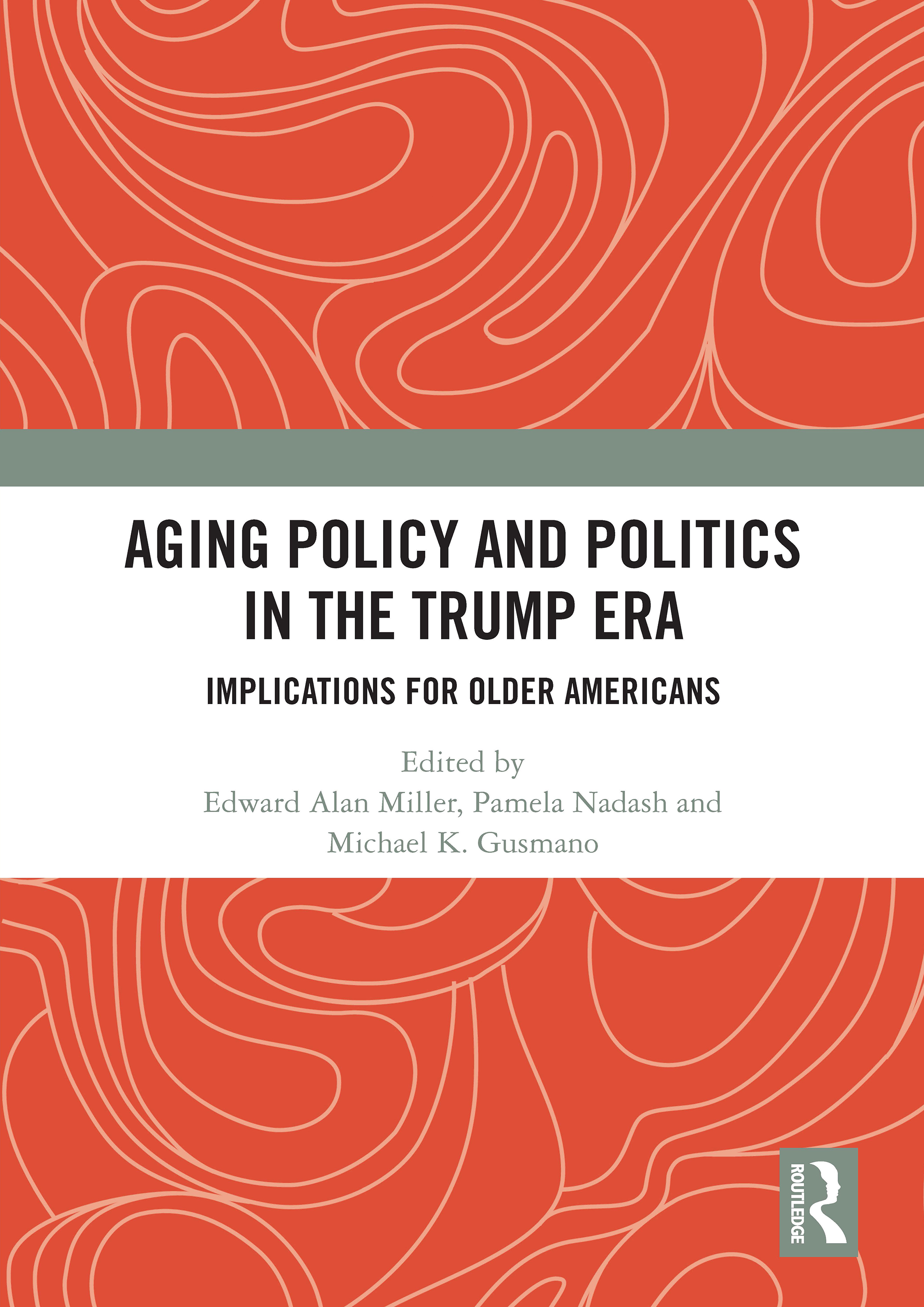
Aging Policy and Politics in the Trump Era The surprise election of Donald J. Trump to the presidency of the United States marks a singular turning point in the American republic – not only because of his idiosyncratic approach to the office, but also because the Republican Party now holds the presidency and both houses of Congress, presenting a historic opportunity for change. The role of older Americans has been critical in both shaping and reacting to this political moment. Their political orientations and behaviors have shaped it through their electoral support for Republican candidates. But, older Americans stand as highly invested stakeholders in the policy decisions made by the very officials they elected and as beneficiaries of the programs that Republicans have targeted for cuts or elimination. This comprehensive volume explores the ways in which Trump administration policies are likely to significantly undermine the social safety net for near-elderly and older Americans, including long-term care, housing, health care, and retirement. The authors also explore how the Trump administration might shape politics and political behavior through the policy changes made. The response of older voters, in upcoming elections, to efforts by the Trump administration and its Republican allies in Congress to draw back on the federal government’s commitment to programs and policies affecting them will shape the direction of aging policy and politics for years to come. This book was originally published as a special issue of the Journal of Aging & Social Policy. POLITICAL SCIENCE,General
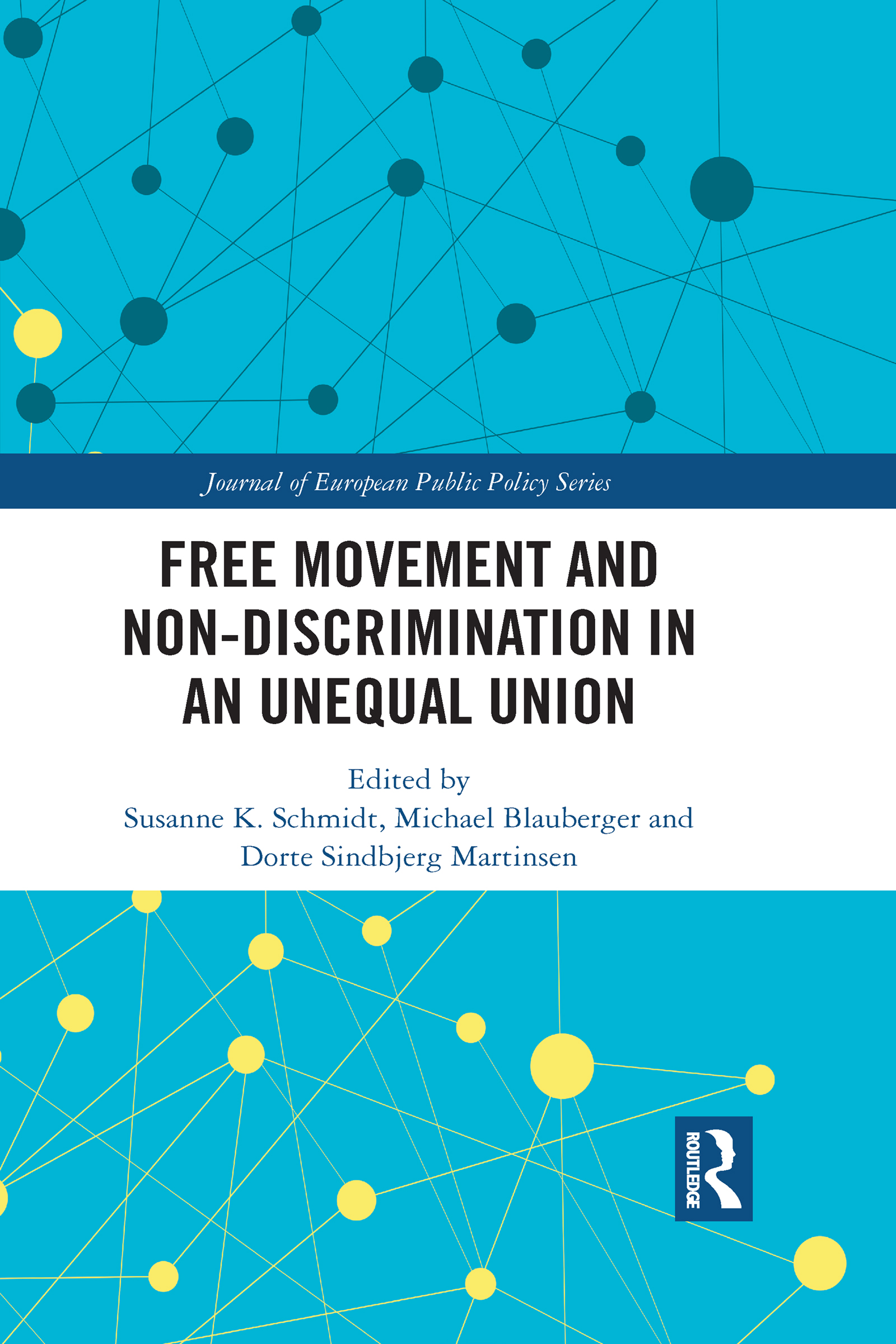
Free Movement and Non-discrimination in an Unequal Union The European Union’s (EU) fundamental principles on free movement of persons and non-discrimination have long challenged the traditional closure of the welfare state. Although EU-wide free movement and national welfare appeared largely unproblematic before Eastern enlargement, the increased differences among EU member states in economic development and welfare provision have resulted in fears about potential welfare migration. Because rights of EU citizens were shaped to an important extent by jurisprudence of the European Court of Justice, these are often not very clearly delineated, and easily politicised. This comprehensive volume shows the normative limits of a strict non-discriminatory approach to EU citizens’ access to national welfare and analyses how the Court developed its jurisprudence, partly reacting to politicisation. Although, empirically, free movement negatively impacts national welfare only under extreme conditions, it is notable that member states have adjusted their social policies in reaction to EU jurisprudence and migration pressure alike. Their heterogeneous institutions of national welfare, administration and labour markets imply for member states that they face very different opportunities and challenges in view of intra-EU migration. This book was originally published as a special issue of the Journal of European Public Policy. POLITICAL SCIENCE,General

The Agency of the Governed in the Global South Research on global norm diffusion and institutional transfer has often neglected the agency of the governed. This collection argues that limited statehood – the lack of state capacities in most parts of the global South – provides opportunities for the governed to raise their voices and be listened to. Thus, people on the receiving end of development cooperation, state building, or security interventions can significantly shape global dynamics of normative and institutional change. Drawing on the emerging body of literature on the agency of the governed, this book assesses the current dynamics of transfer and diffusion studies at the interstice of political science and social anthropology. By focusing on the agency of the governed, the authors integrate a broad spectrum of issues and debates, from the proliferation of global norms to state and security building to international policy cooperation. This book will be of interest to students and researchers of global politics and international relations, particularly those focusing on the global South. It was originally published as a special issue of the online journal Third World Thematics. POLITICAL SCIENCE,General

Secrecy in European Politics Secrecy is a prevalent feature of politics within and among liberal democratic states, as well as in the relations between states and international organisations. However, surprisingly little research in political science has explored the effects of secrecy on policy making; the evolution of the regulatory frameworks that govern the use of secrecy; and the tensions between secrecy and transparency. This fascinating volume examines secrecy in European politics across a range of EU and national settings and policy domains, exploring the technological, social and political developments which appear to signal the end of privacy and the rapid expansion of political secrecy in European multi-level settings. Consequently, the tensions between democratic accountability with its transparency requirements, and political secrecy, which is typically justified on grounds of effectiveness of state action, have become more marked and more politicised. Engaging with these developments, the authors focus on actors’ motivations in secret politics; institutional perspectives that highlight contestation over secrecy norms; and organisational perspectives that emphasise the diversity of secrecy cultures. This book will be of great interest to students, researchers and professionals of political science and law. It was originally published as a special issue of the journal West European Politics. POLITICAL SCIENCE,General
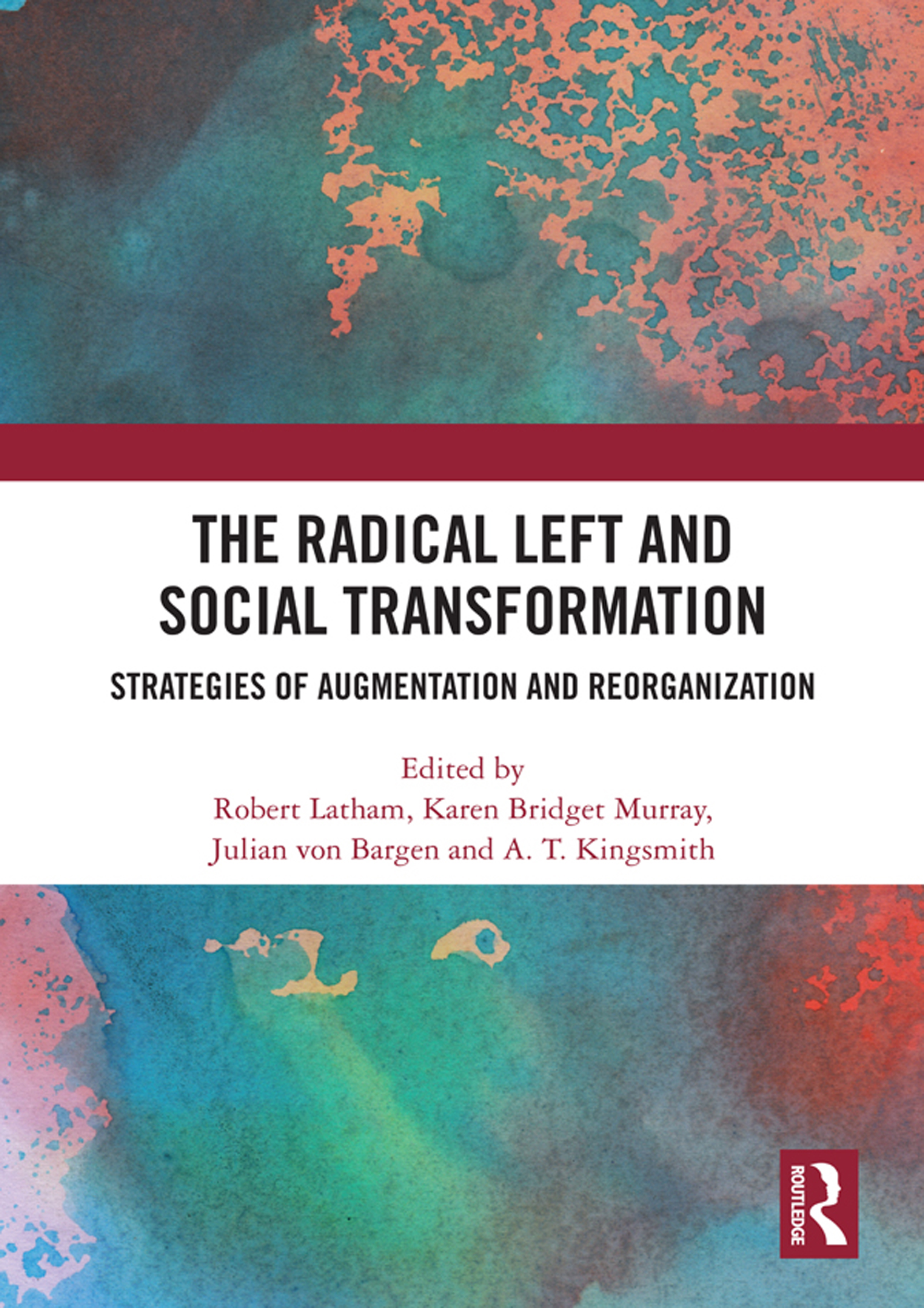
The Radical Left and Social Transformation This comprehensive collection draws upon and reengages with a long history of Marxian-anchored thought to analyze the potential for social transformation through a reinvigorated radical Left, all within the context of the ascendance of an increasingly ethnonationalist, patriarchal, and authoritarian far Right worldwide. The authors identify and reflect on strategies, tactics, and possibilities for analyzing and intervening in advanced capitalist societies by increasing and deepening popular participation and support on the far Left. The chapters are framed in terms of conceptualizing the capitalist present, organizing "the people" and reimagining the radical Left. Together, in diverse ways that draw upon both qualitative and quantitative approaches, the authors evaluate the difficulties of augmentation across multiple planes, from the tension between migrants and citizen workers, to the uneasy relationship between sovereignty and class, to the contradictions operating across international versus domestic dynamics. How and why (if at all) should the radical Left reexamine its understanding of political consciousness, identity, ideology, and institutions, as they relate to Marxian analysis and various threads of critical theory? The authors suggest new approaches for understanding what the radical Left is up against and how problematic barriers might be torn down, thus disrupting unhelpful binaries such as state versus capital, national versus international, worker versus migrant, activist versus candidate, and freedom versus necessity. This book was originally published as a special issue of the online journal Global Discourse. POLITICAL SCIENCE,General

National Security The seventh edition of this highly successful textbook analyzes the history, evolution, and processes of national security policies. It examines national security from two fundamental fault lines - the end of the Cold War and the evolution of contemporary terrorism dating from the 9/11 terrorist attacks - and traces their path up to ISIS and beyond. The book considers how the resulting era of globalization and geopolitics guides policy. Placing these trends in conceptual and historical context and following them through military, semimilitary, and nonmilitary concerns, National Security treats its subject as a nuanced and subtle phenomenon that encompasses everything from the global to the individual with the nation at its core. New to the Seventh Edition An assessment of the impact of the Trump presidency on national security and relevant domestic policies, including border security and energy security matters. The continuing impact and evolution of terrorism as a security problem, with notable emphasis on the decline of the Islamic State (IS) and what terrorist threats are likely to succeed it. A description of the cyber security problem with an emphasis on Russian efforts to interfere with the 2016 US presidential election and beyond. A revised delineation of the geographic and substantive challenges facing the United States in the form of a chapter on "lethal landscapes," emphasizing the rise of China as a global rival and opponent in Asia and an attempt to deal with state aspirants like the Kurds. This book will continue to be highly beneficial to students and scholars working and studying in security studies, military and strategic studies, defense studies, foreign policy, US politics and international relations. POLITICAL SCIENCE,General

The Making of the Conservative Party’s Immigration Policy This book explains the development of the Conservative Party’s immigration policy during the seven decades since 1945, up to today. By bringing together existing theories from the fields of political science and migration studies, this book offers a new model of party policy-making, which could be modified and tested in other contexts. Grounded in rigorous scholarship, but of interest to general readers as well as specialists and students, this book provides a thoughtful and engaging account of the making of modern Britain. The book draws on 30 interviews with figures who were at the heart of policy-making, from Kenneth Clarke and Douglas Hurd, to Damian Green and Gavin Barwell, to reveal that the ‘national mood’ often has more impact on policy-making than the empirics of the situation. This book will be of key interest to scholars, students and readers interested in British politics; immigration and migration studies; Conservative Party politics; and, more broadly, public policy, political parties and European and comparative politics. POLITICAL SCIENCE,General
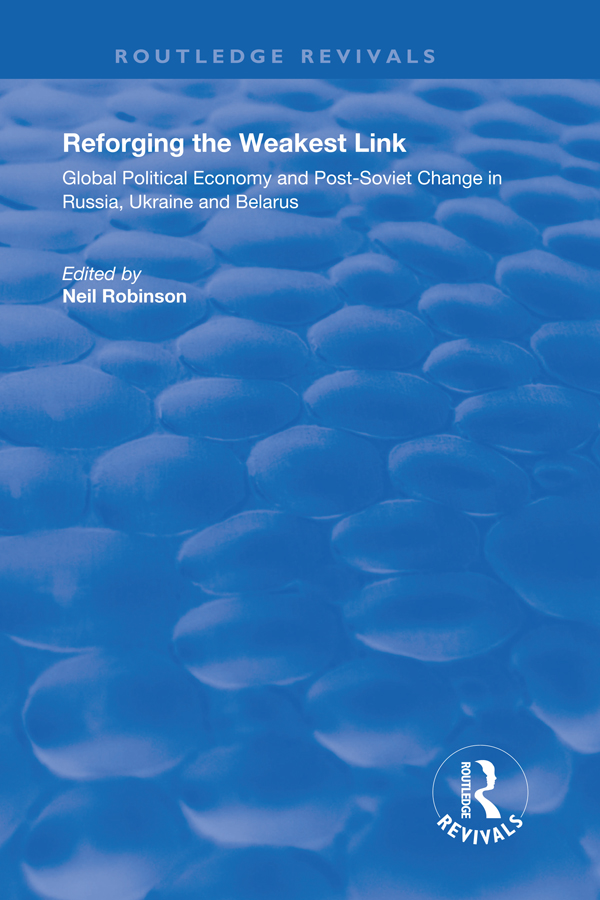
Reforging the Weakest Link Originally published in 2004. The collapse of the USSR and the emergence of 15 new states from its ashes presents another challenge to the global economy: how to reintegrate the post-Soviet space into the international economy. The spread of liberal market ideology and integration of national economic spaces into a global marketplace faces unique difficulties in the former USSR. This insightful volume explains these challenges, showing how Soviet legacies have worked against a smooth re-entry of Russia, Ukraine and Belarus into the global economy. It also demonstrates how and why global economic forces have had very uneven effects in the area, how the area differs from other parts of the post-communist world where reintegration has proceeded more smoothly, and what the future prospects and political implications are for the region in the global economy. POLITICAL SCIENCE,General
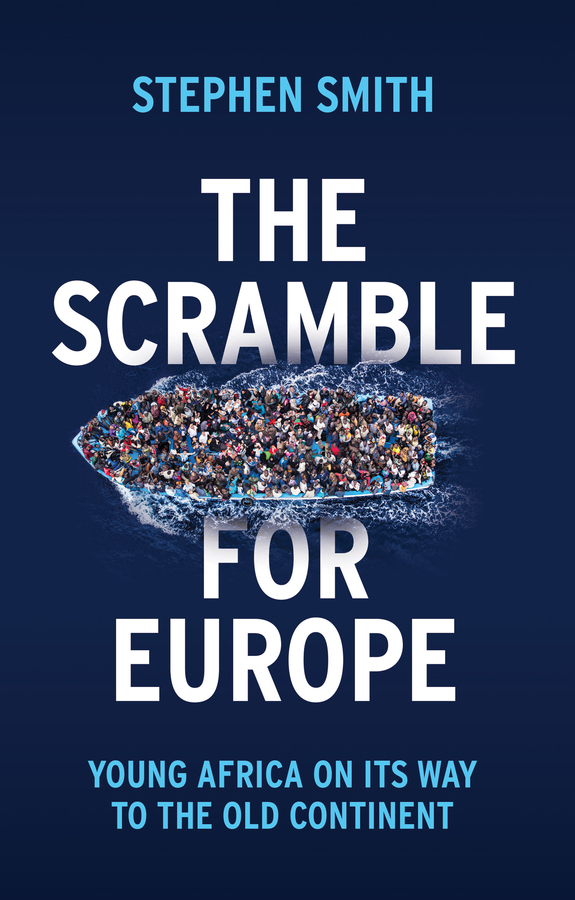
The Scramble for Europe From the harrowing situation of migrants trying to cross the Mediterranean in rubber dinghies to the crisis on the US-Mexico border, mass migration is one of the most urgent issues facing our societies today. At the same time, viable solutions seem ever more remote, with the increasing polarization of public attitudes and political positions. In this book, Stephen Smith focuses on ‘young Africa’ – 40 per cent of its population are under fifteen – anda dramatic demographic shift. Today, 510 million people live inside EU borders, and 1.25 billion people in Africa. In 2050, 450 million Europeans will face 2.5 billion Africans – five times their number. The demographics are implacable. The scramble for Europe will become as inexorable as the ‘scramble for Africa’ was at the end of the nineteenth century, when 275 million people lived north and only 100 million lived south of the Mediterranean. Then it was all about raw materials and national pride, now it is about young Africans seeking a better life on the Old Continent, the island of prosperity within their reach. If Africa’s migratory patterns follow the historic precedents set by other less developed parts of the world, in thirty years a quarter of Europe’s population will beAfro-Europeans. Addressingthe question of how Europe cancope with an influx of this magnitude, Smith argues for a path between the two extremes of today’s debate. He advocatesmigratory policies of ‘good neighbourhood’ equidistant from guilt-ridden self-denial and nativist egoism. This sobering analysis of the migration challenges we now face will be essential reading for anyone concerned with the great social and political questions of our time. POLITICAL SCIENCE,General
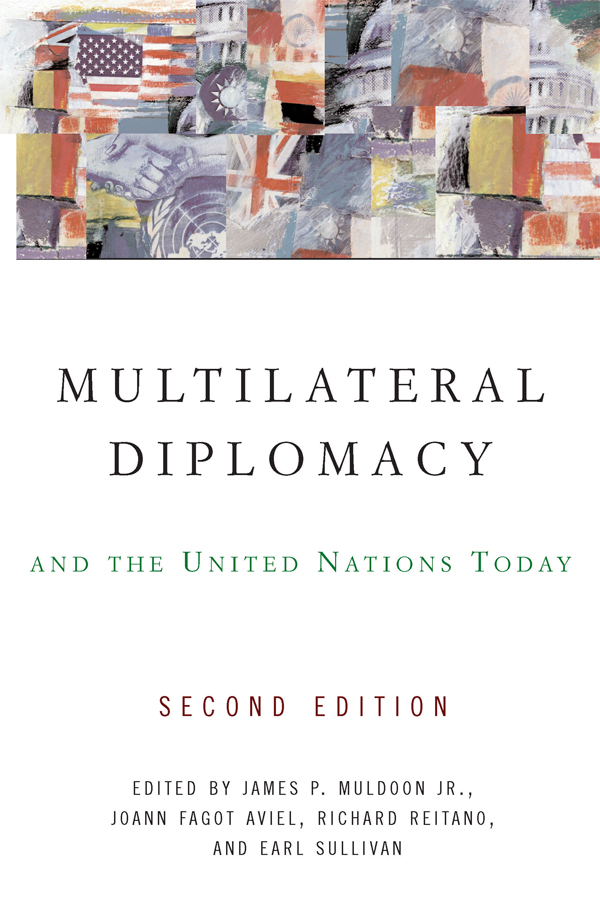
Multilateral Diplomacy and the United Nations Today As the world confronts new and ongoing challenges of globalization, international terrorism and an array of other global issues, the United Nations and its key attribute-multilateral diplomacy-are more important now than ever before. With new and updated essays that detail the experiences of a diverse group of practitioners and scholars who work in the field of diplomacy, this new edition covers in even greater breadth and depth the quintessential characteristics of multilateral diplomacy as it is conducted within the United Nations framework. Multilateral Diplomacy and the United Nations Today provides valuable insights from a variety of perspectives on how diplomacy is practiced, making it essential reading for aspiring diplomats, international business leaders, and students of all levels. The contributors to this volume bring a depth and breadth of knowledge and experience to the examination of five areas of multilateral diplomacy: UN diplomacy, crisis diplomacy, international economic diplomacy, UN summits and "citizen diplomats," and non-governmental diplomacy. A thorough revision: of the 24 chapters, eight are new to this edition, and all the others are updated. Includes a diverse range of contributors: veteran diplomats, respected scholars, non-governmental activists. Relevant, timely discussion topics related to the UN. An important supplemental text to any course on the UN, contemporary international relations, diplomacy, and international organizations. POLITICAL SCIENCE,General

Diplomacy Lessons John Brady Kiesling, a twenty-year veteran of the foreign service, publicly resigned his position as political counselor of the U.S. Embassy in Athens in February 2003 to protest the Bush administration’s impending invasion of Iraq. He believed that the security, economic, and moral costs of this war, including the blackening of America’s image abroad, would far outweigh any benefit to the American people. In Diplomacy Lessons , Kiesling reminds readers that U.S. power does not rest on military might alone and that anger at America has real consequences for U.S. national interests.The security and prosperity of the American people depend on efficient cooperation with foreigners on a range of issues, not only terrorism and nuclear nonproliferation but also trade policy, environmental protection, and even public health. The policy decisions of America’s foreign partners are driven by domestic politics, just as they are in the United States, and effective U.S. diplomacy requires understanding these political realities. An unloved superpower faces significant costs, both economic and strategic, in the pursuit of its interests. Kiesling calls for a return to realist policy making that recognizes the limits of U.S. power and uses thoughtful diplomacy to legitimize our security requirements in the eyes of our international partners.This book is, at heart, an argument for how to best achieve America’s goals abroad. Kiesling’s passionate critique of current U.S. foreign policy and his prescriptions for restoring American influence and legitimacy will interest anyone concerned about the future of U.S. and world affairs. POLITICAL SCIENCE,General
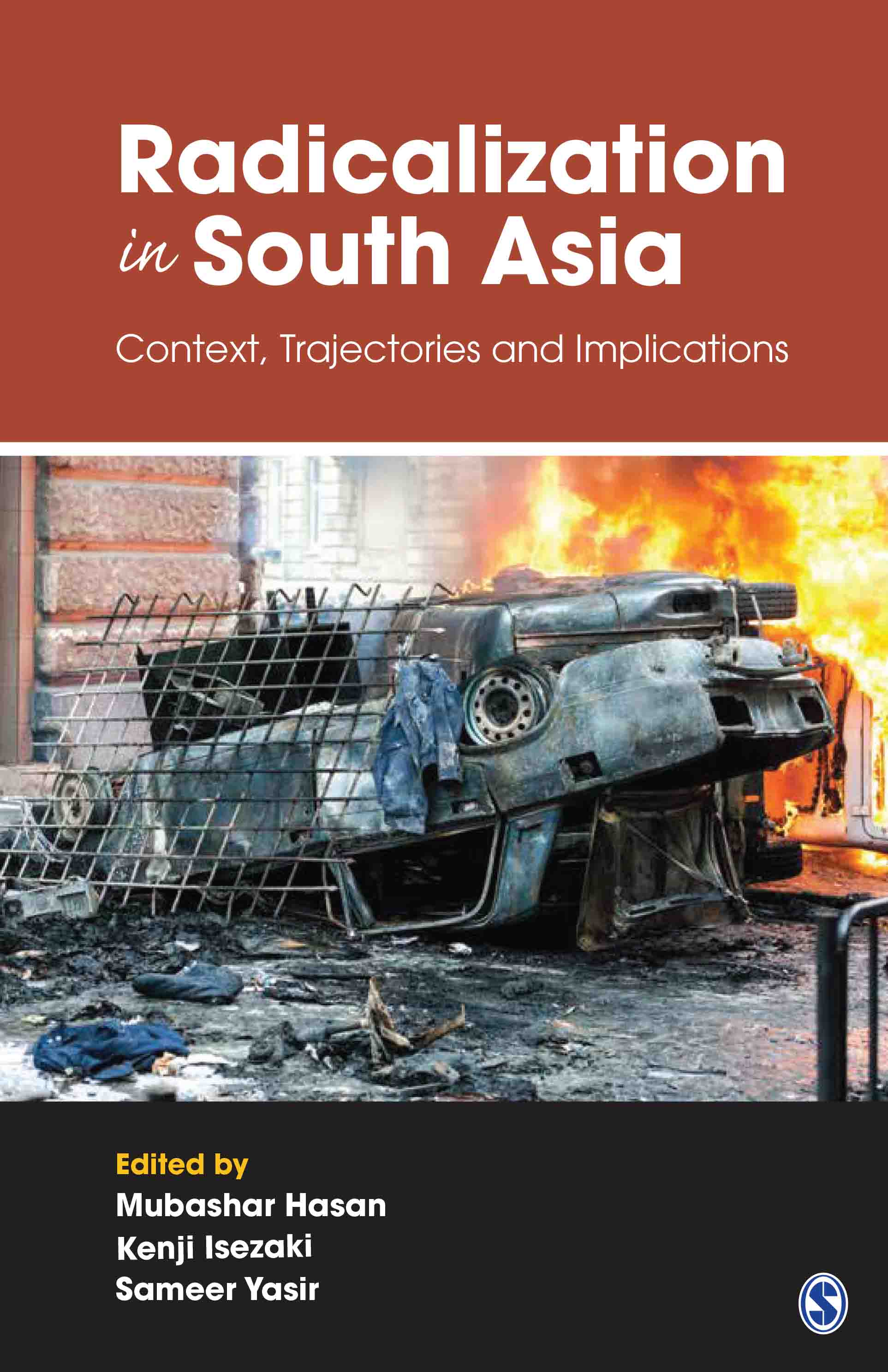
Radicalization in South Asia Presents a timely discourse to engage with issues of radicalization in South Asia and offers a diverse overview of radicalization and de-radicalization across South Asian societies. POLITICAL SCIENCE,General
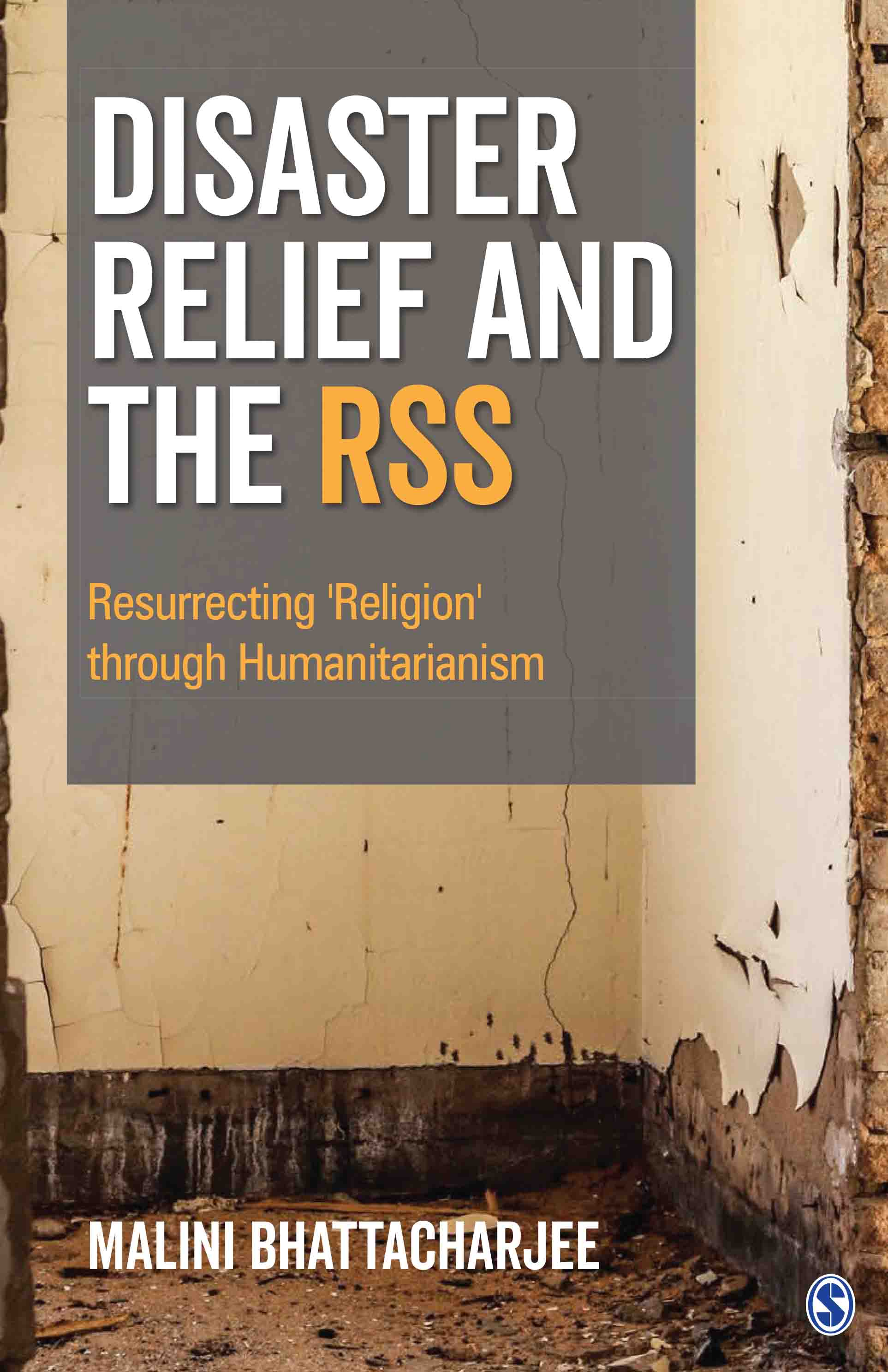
Disaster Relief and The RSS A refreshingly new perspective of the RSS by recognizing its ‘compassionate’ aspects through an analysis of its humanitarian activities in disaster contexts POLITICAL SCIENCE,General

Triggered This is the book that the leftist elites don't want you to read -- Donald Trump, Jr., exposes all the tricks that the left uses to smear conservatives and push them out of the public square, from online "shadow banning" to rampant "political correctness." In Triggered, Donald Trump, Jr. exposes all the tricks that the left uses to smear conservatives and push them out of the public square, from online "shadow banning" to fake accusations of "hate speech." No topic is spared from political correctness. This is the book that the leftist elites don't want you to read! Trump, Jr. writes about the importance of fighting back and standing up for what you believe in. From his childhood summers in Communist Czechoslovakia that began his political thought process, to working on construction sites with his father, to the major achievements of President Trump's administration, Donald Trump, Jr. spares no details and delivers a book that focuses on success and perseverance, and proves offense is the best defense. POLITICAL SCIENCE,General

Pennsylvania Politics and Policy, Volume 2 Designed to showcase current issues of interest, Pennsylvania Politics and Policy, Volume 2 isthe second reader consisting of updated chapters from recent issues of Commonwealth: A Journal of Pennsylvania Politics and Policy. The editors and contributors to this volume focus on government institutions, election laws, the judiciary, government finance and budgeting, the opioid crisis, childcare, property taxes, environmental policy, demographics, and more. Each chapter is supplemented by discussion questions, suggestions for further reading, and forums with arguments in support of or opposed to contested elements of state policy. In addition, Pennsylvania Politics and Policy, Volume 2 includes a detailed guide to researching state government and policy online, as well as a comprehensive chapter on the structure of Pennsylvania government. It is designed as a text or supplement for college or advanced high school classes in American government, state and local politics, public policy, and public administration. Contributors include: John Arway, Jenna Becker Kane, Jeffrey Carroll, Bob Dick, Ashley Harden, Stefanie I. Kasparek, Vera Krekanova, Maureen W. McClure, John F. McDonald, Josh Shapiro, Marc Stier, Jennie Sweet-Cushman, James Vike, and the editors. POLITICAL SCIENCE,General

Developing Countries And The Multilateral Trading System This book provides a historical perspective of the Uruguay Round agreement and focuses on the interaction between the developed and developing countries on matters relating to the global trading system and its disciplines since the founding of General Agreement on Tariffs and Trade. POLITICAL SCIENCE,General
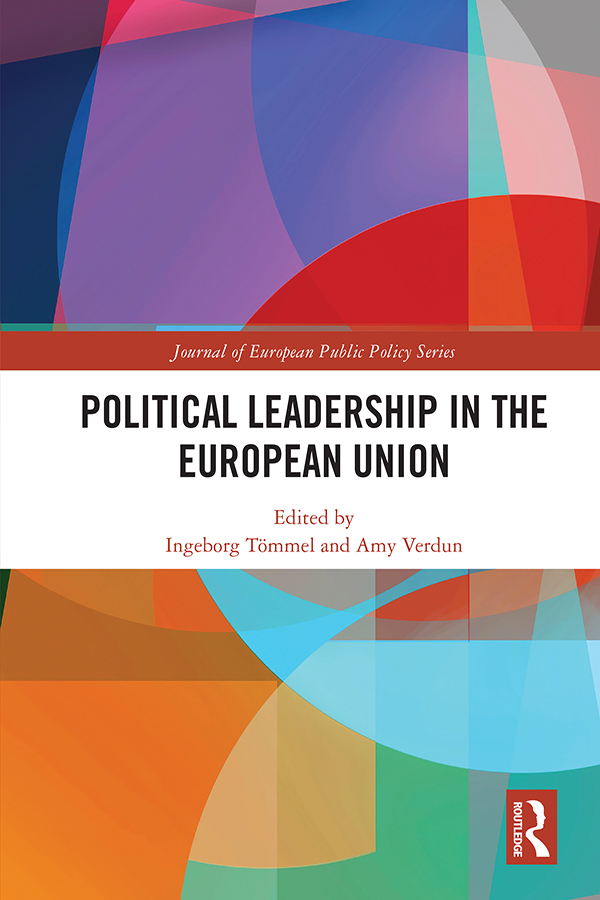
Political Leadership in the European Union The challenges that have been facing the European Union in recent years have given rise to the question: who leads the EU? This book offers a systematic analysis of political leadership in the EU. This volume offers a theoretical and conceptual analysis of political leadership in the EU. It deals with questions such as what kind of leadership is there in the different domains (such as climate change or central banking). It also examines how various EU institutions (European Commission, European Parliament) exert or have exerted leadership. Furthermore, it examines the role of the presidents of some of these institutions, such as the European Commission the European Council, the European Central Bank, but also of selected national leaders. Although the book does not advance a single leadership concept, the findings of the individual case studies show that the EU is by no means leaderless. The chapters originally published as a special issue in the Journal of European Integration. POLITICAL SCIENCE,General

Brexit This book offers a comprehensive political assessment of Brexit. Based on a historical review of the role of the United Kingdom in the European Union, the author, a former diplomat at the German embassy in London, presents well-founded insights into arguments in favor and against the Brexit deal and the status quo of the Brexit negotiations. Furthermore, the book discusses the consequences of Brexit – for the UK and the rest of the EU, for security in Europe, and for the transatlantic relationship, as well as for global trade relations and the competitiveness of Europe and the UK. POLITICAL SCIENCE,General

Theory and Methods in Political Science This leading text provides an ideal foundation for study and research in political science, bringing together renowned figures in the field to introduce the key approaches and methods used in the study of politics. The fully revised fourth edition features a considerable updating in the team of contributors and the range of coverage and examples. POLITICAL SCIENCE,General
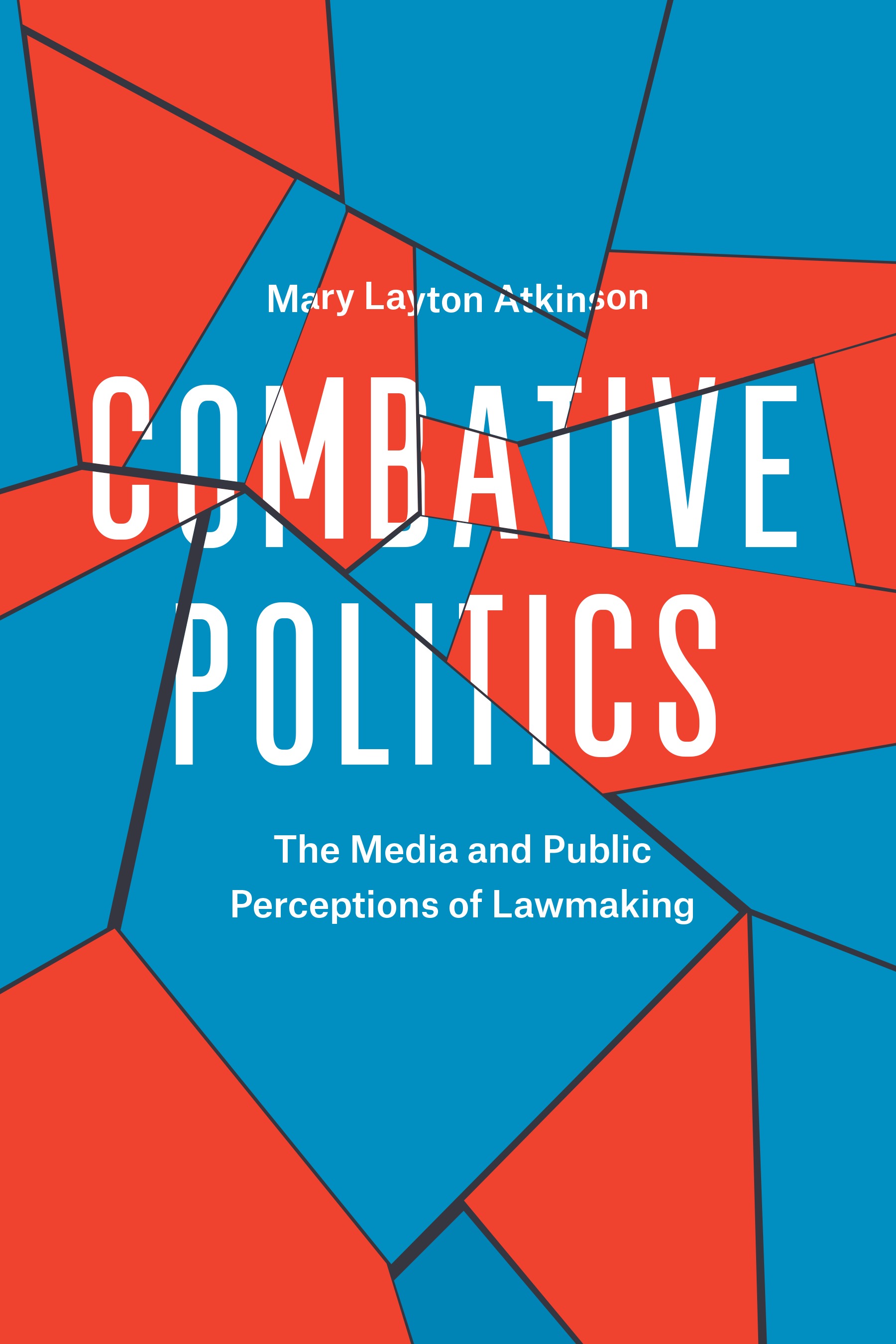
Combative Politics From the Affordable Care Act to No Child Left Behind, politicians often face a puzzling problem: although most Americans support the aims and key provisions of these policies, they oppose the bills themselves. How can this be? Why does the American public so often reject policies that seem to offer them exactly what they want? By the time a bill is pushed through Congress or ultimately defeated, we’ve often been exposed to weeks, months—even years—of media coverage that underscores the unpopular process of policymaking, and Mary Layton Atkinson argues that this leads us to reject the bill itself. Contrary to many Americans’ understandings of the policymaking process, the best answer to a complex problem is rarely self-evident, and politicians must weigh many potential options, each with merits and drawbacks. As the public awaits a resolution, the news media tend to focus not on the substance of the debate but on descriptions of partisan combat. This coverage leads the public to believe everyone in Washington has lost sight of the problem altogether and is merely pursuing policies designed for individual political gain. Politicians in turn exacerbate the problem when they focus their objections to proposed policies on the lawmaking process, claiming, for example, that a bill is being pushed through Congress with maneuvers designed to limit minority party input. These negative portrayals become linked in many people’s minds with the policy itself, leading to backlash against bills that may otherwise be seen as widely beneficial. Atkinson argues that journalists and educators can make changes to help inoculate Americans against the idea that debate always signifies dysfunction in the government. Journalists should strive to better connect information about policy provisions to the problems they are designed to ameliorate. Educators should stress that although debate sometimes serves political interests, it also offers citizens a window onto the lawmaking process that can help them evaluate the work their government is doing. POLITICAL SCIENCE,General
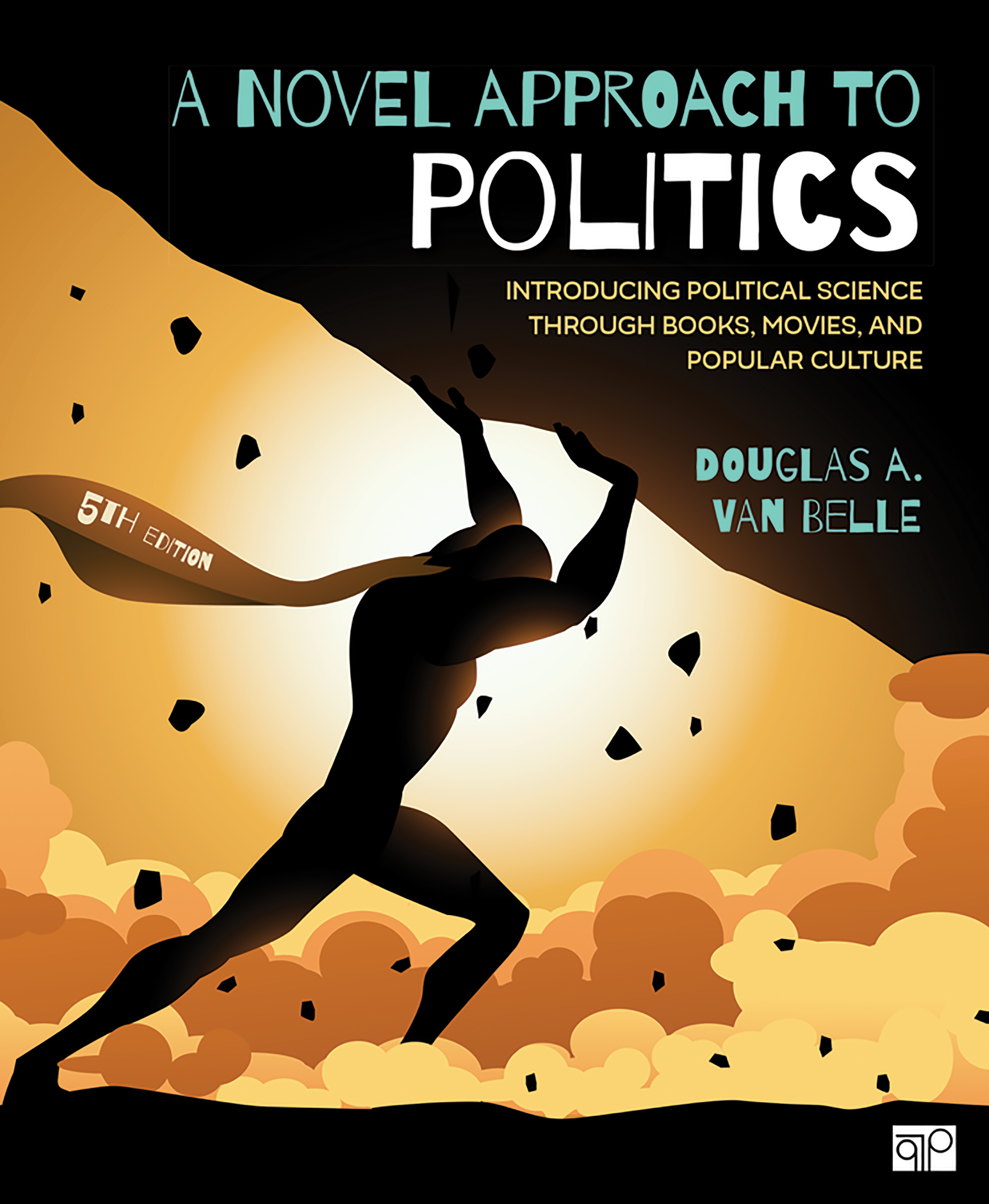
A Novel Approach to Politics A Novel Approach to Politics turns conventional textbook wisdom on its head by using pop culture references to illustrate key concepts and cover recent political events. This is a textbook you will want to read. Adopters of previous editions from schools all over the country are thanking author Douglas A. Van Belle for some of their best student evaluations to date. With this Fifth Edition, Douglas A. Van Belle brings the book fully up to date with recent events such as Trump’s executive orders on immigration, the 2016 elections in the US, current policy debates including recent court decisions that may affect gerrymandering, international happenings such as Brexit, and other assorted intergalactic matters. Van Belle adds a wealth of new and recent movies and books to the text, as he illustrates key concepts in political science through examples that captivate you. Employing a wide range of references from 1984 to Game of Thrones to House of Cards, students are given a solid foundation in institutions, ideology, and economics. To keep things grounded, the textbook nuts and bolts are still there to aid students, including chapter objectives, chapter summaries, bolded key terms, and discussion questions. POLITICAL SCIENCE,General
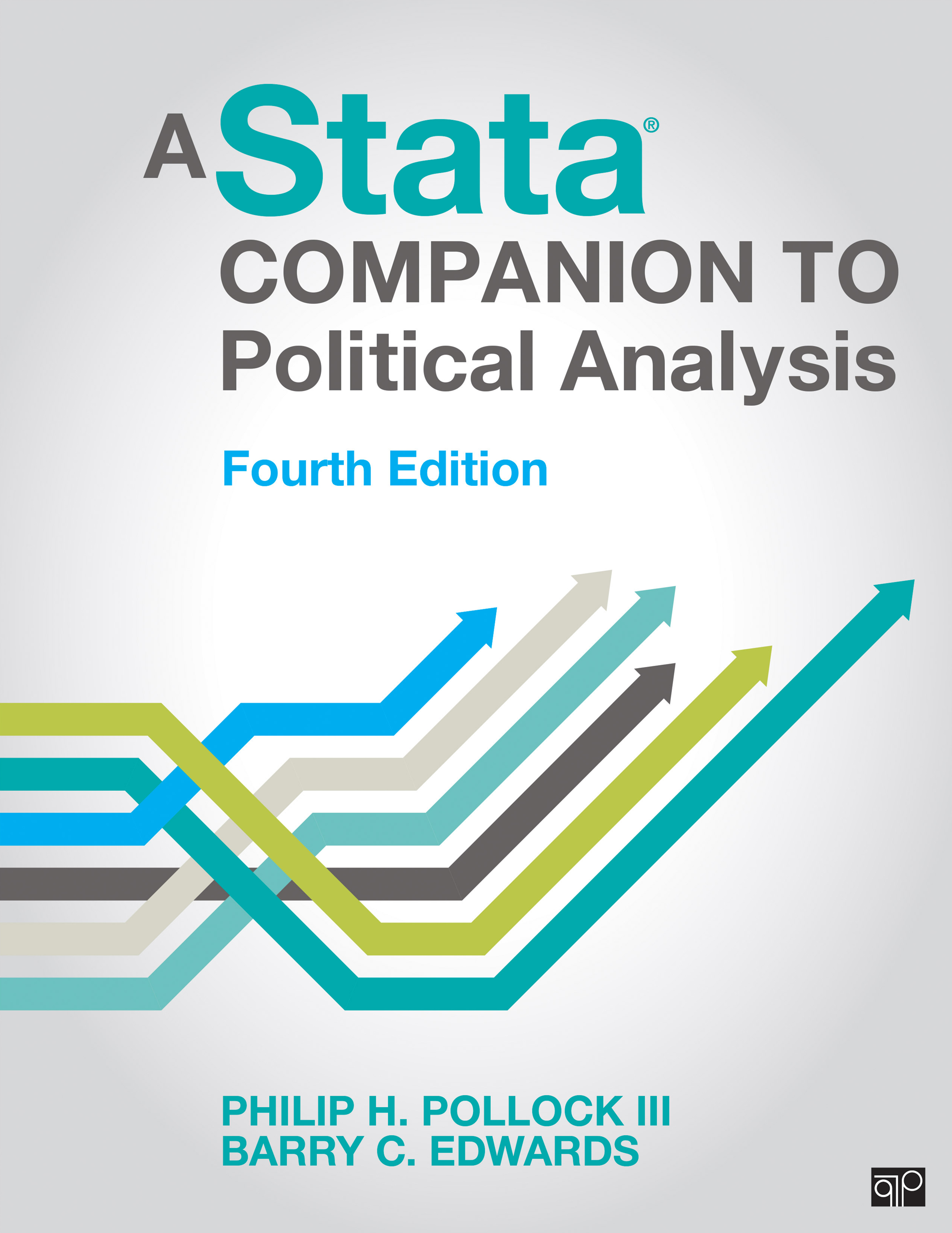
A Stata® Companion to Political Analysis Popular for its speed, flexibility, and attractive graphics, Stata is a powerful tool for political science students. With Philip Pollock's Fourth Edition of A Stata® Companion to Political Analysis, students quickly learn Stata via step-by-step instruction, more than 50 exercises, customized datasets, annotated screen shots, boxes that highlight Stata's special capabilities, and guidance on using Stata to read raw data. This attractive and value-priced workbook, an ideal complement to Pollock’s Essentials of Political Analysis, is a must-have for any political science student working with Stata. POLITICAL SCIENCE,General
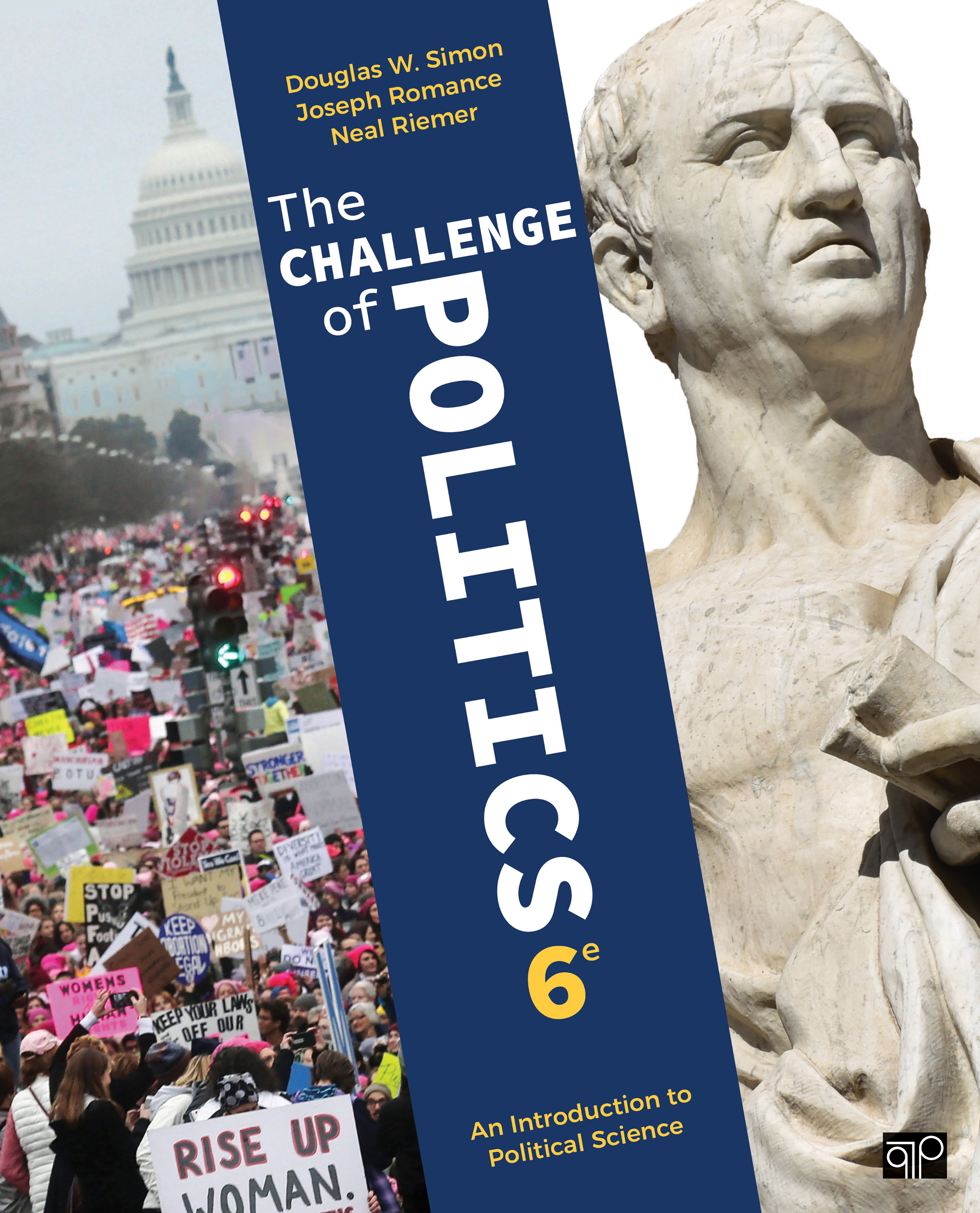
The Challenge of Politics This updated Sixth Edition of The Challenge of Politics enables you to see how the subfields of political science converge around a set of crucial questions, such as “Can we as citizens and students articulate and defend a view of the good political life and its guiding political values?†“Can we bring political wisdom to bear on judgments about politics and public issues?†and “Can we develop a science of politics to help us understand significant political phenomena—the empirical realities of politics?†Balancing lessons of classic and contemporary theory with contemporary politics and empirical study, the book equips you with the tools you need to explore the impact of philosophy and ideology, recognize major forms of government, evaluate empirical findings, and understand how policy issues directly affect people’s lives. This Sixth Edition includes a brand-new chapter on American Politics and Government and updated content on recent international events. POLITICAL SCIENCE,General
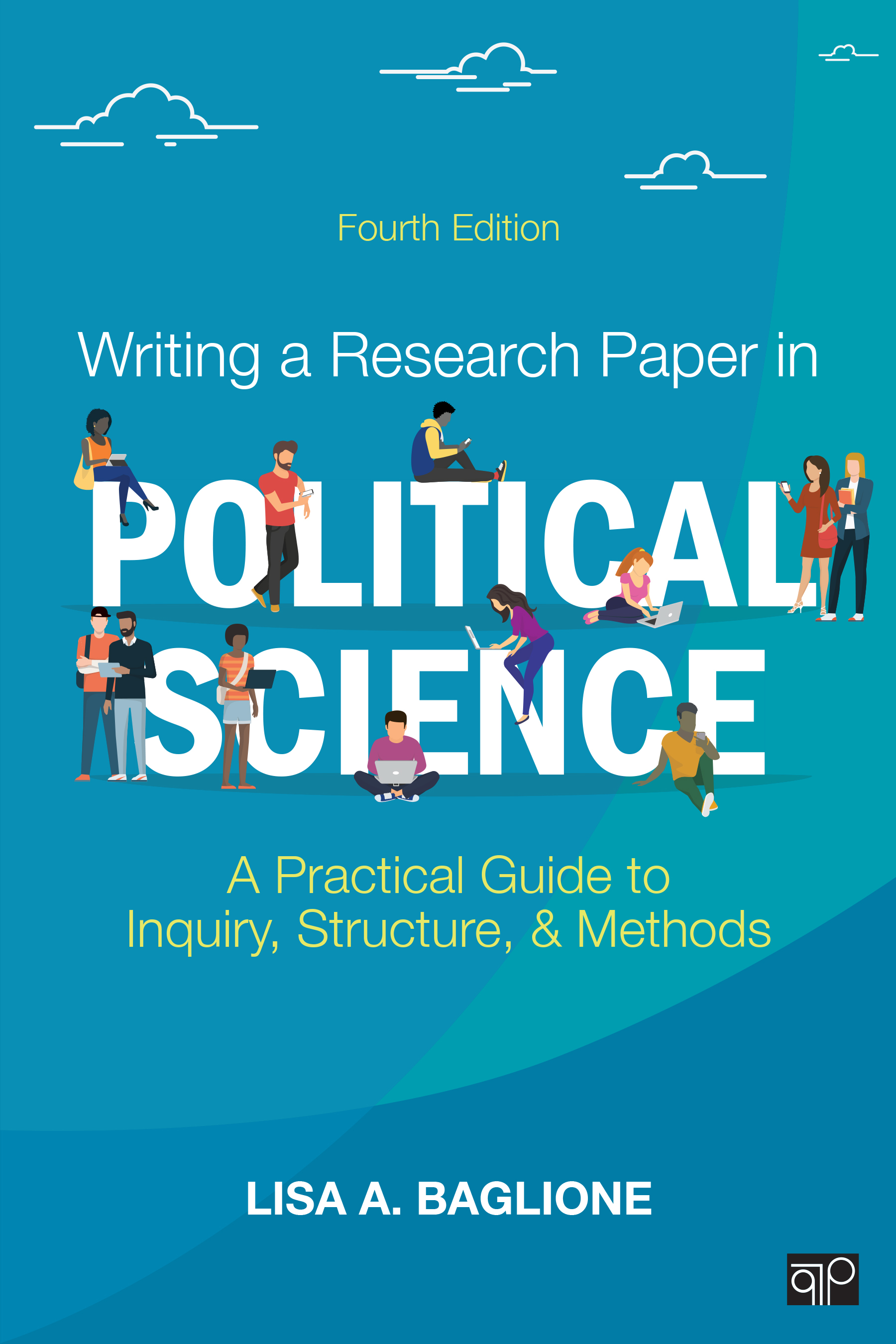
Writing a Research Paper in Political Science Even students capable of writing excellent essays still find their first major political science research paper an intimidating experience. Crafting the right research question, finding good sources, properly summarizing them, operationalizing concepts and designing good tests for their hypotheses, presenting and analyzing quantitative as well as qualitative data are all tough-going without a great deal of guidance and encouragement. Writing a Research Paper in Political Science breaks down the research paper into its constituent parts and shows students what they need to do at each stage to successfully complete each component until the paper is finished. Practical summaries, recipes for success, worksheets, exercises, and a series of handy checklists make this a must-have supplement for any writing-intensive political science course. POLITICAL SCIENCE,General

An IBM® SPSS® Companion to Political Analysis In Philip H. Pollock III and Barry C. Edwards’ trusted IBM SPSS® workbook, students dive headfirst into actual political data and work with a software tool that prepares them not only for future political science research, but the job world as well. Students learn by doing with new guided examples, annotated screenshots, step-by-step instructions, and exercises that reflect current scholarly debates in American political behavior and comparative politics. This Sixth Edition of An IBM SPSS® Companion to Political Analysis features thoroughly revised and updated datasets and is compatible with all post-12 releases of SPSS. POLITICAL SCIENCE,General
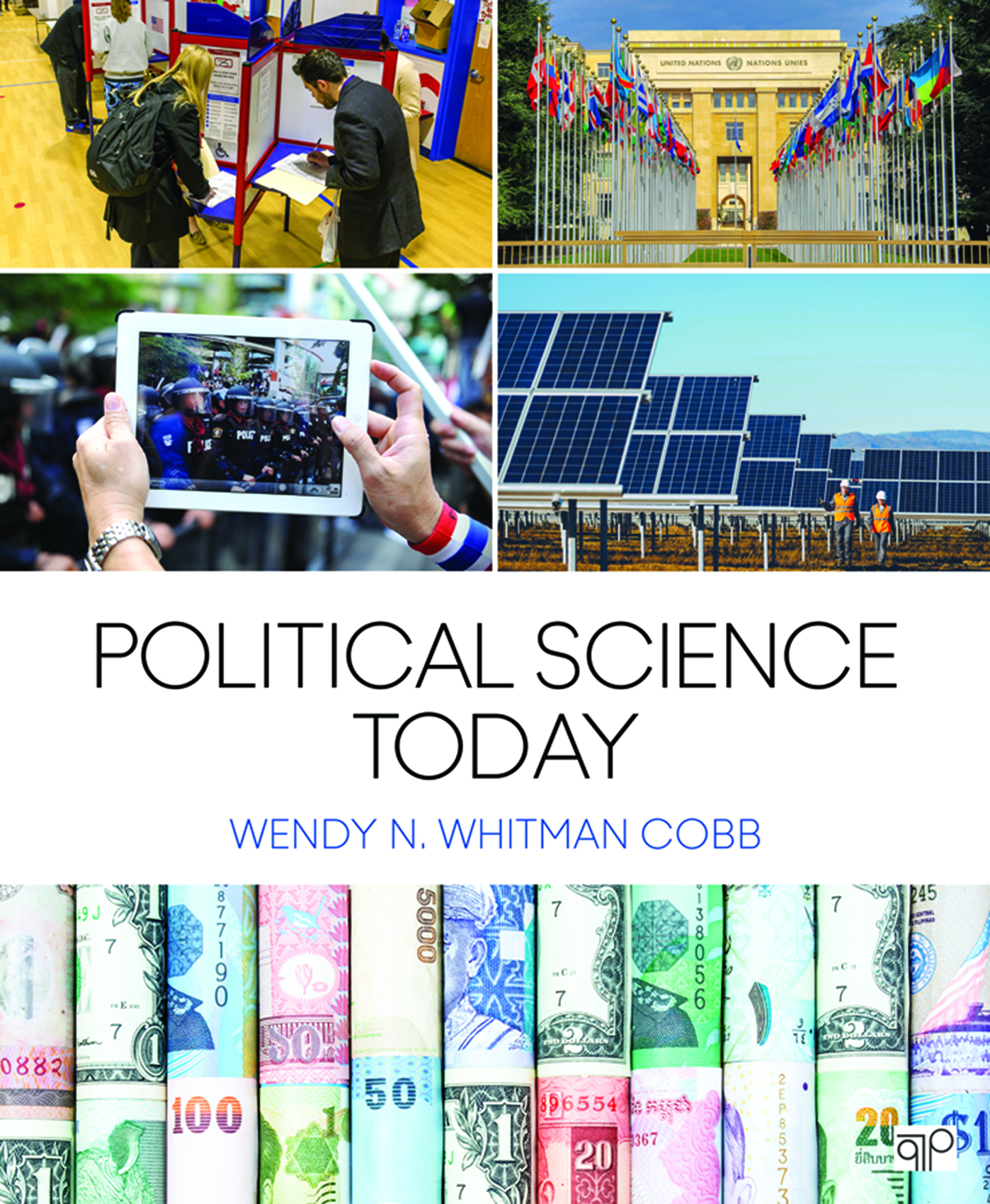
Political Science Today Political science has changed; the way students learn has changed; so too should the way it’s taught. This is political science, today. Political Science Today by Wendy Whitman Cobb gives you a holistic view of the subfields that make up political science by dedicating one chapter to each of the topics at the core of the discipline. Unlike denser texts on the market, Political Science Today uses a field-based approach that allows you to engage with the material directly and dig into each of the discipline’s diverse subfields while also developing critical thinking skills, discerning the differences between politics and political science, conducting and consuming research, and broadening your future career aspirations. The book’s innovative table of contents begins with foundational tools like theories and research methods, then builds up to subfield chapters on Comparative Politics, International Relations, American Government, Political Economy, and Public Policy and Administration. Current case studies throughout the text provide a backdrop for engaging classroom discussions on topics such as President Trump’s travel ban, ISIS as a state, and strengths and weaknesses of the United Nations. This unique approach provides short segments of topic coverage, plenty of summarizing content and review questions, as well as comprehensive learning objectives which will help you understand the realities of political science today. POLITICAL SCIENCE,General
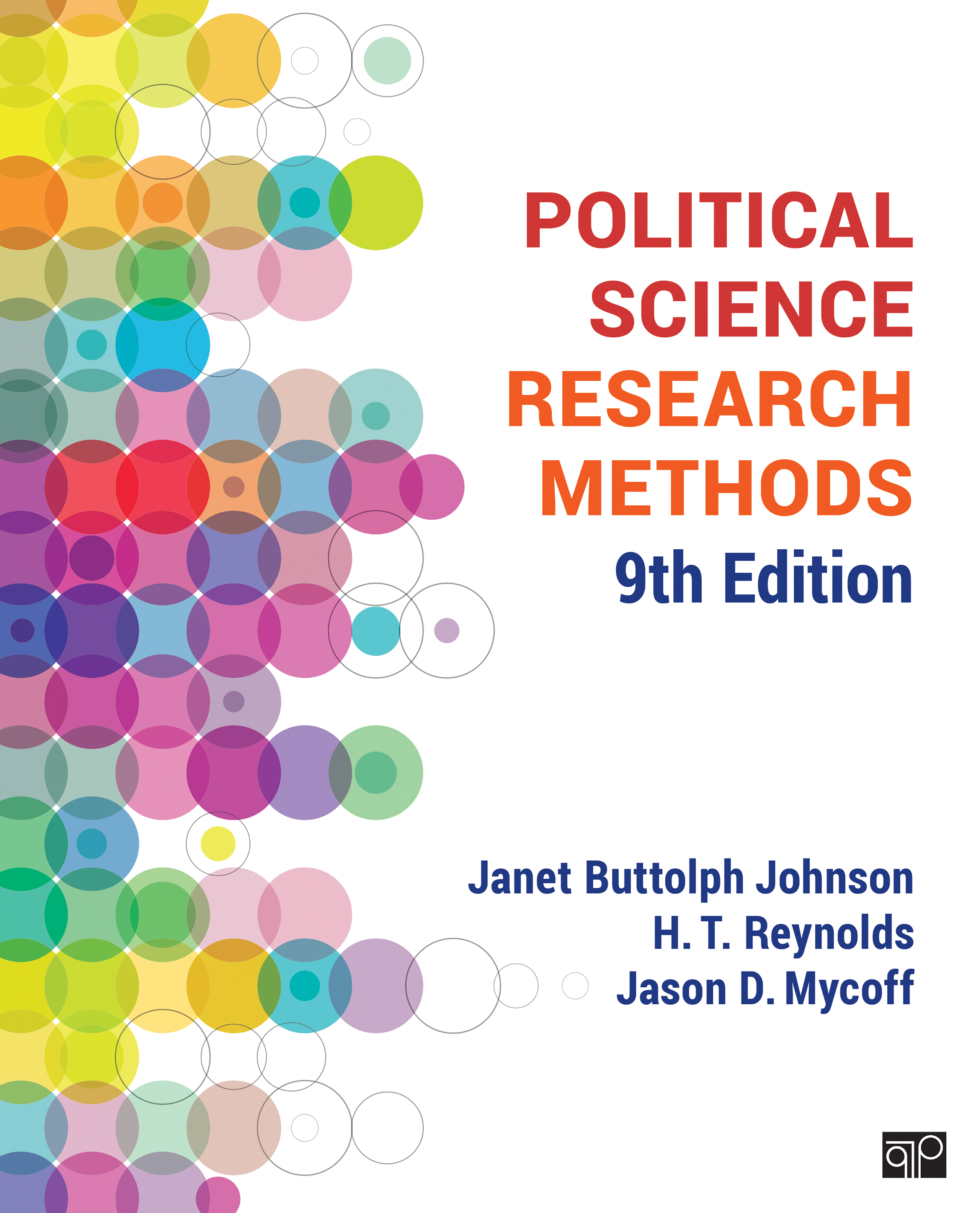
Political Science Research Methods Understand the “how†and the “why†behind research in political science. Political Science Research Methods by Janet Buttolph Johnson, H. T. Reynolds, and Jason D. Mycoff helps you to understand the logic behind research design by guiding you through a step-by-step process that explains when and why a researcher would pursue different kinds of methods. The highly anticipated Ninth Edition of this trusted resource provides more international examples, an increased focus on the role ethics play in the research process, increased attention to qualitative research methods, and expanded coverage on the role of the internet in research and analysis. POLITICAL SCIENCE,General
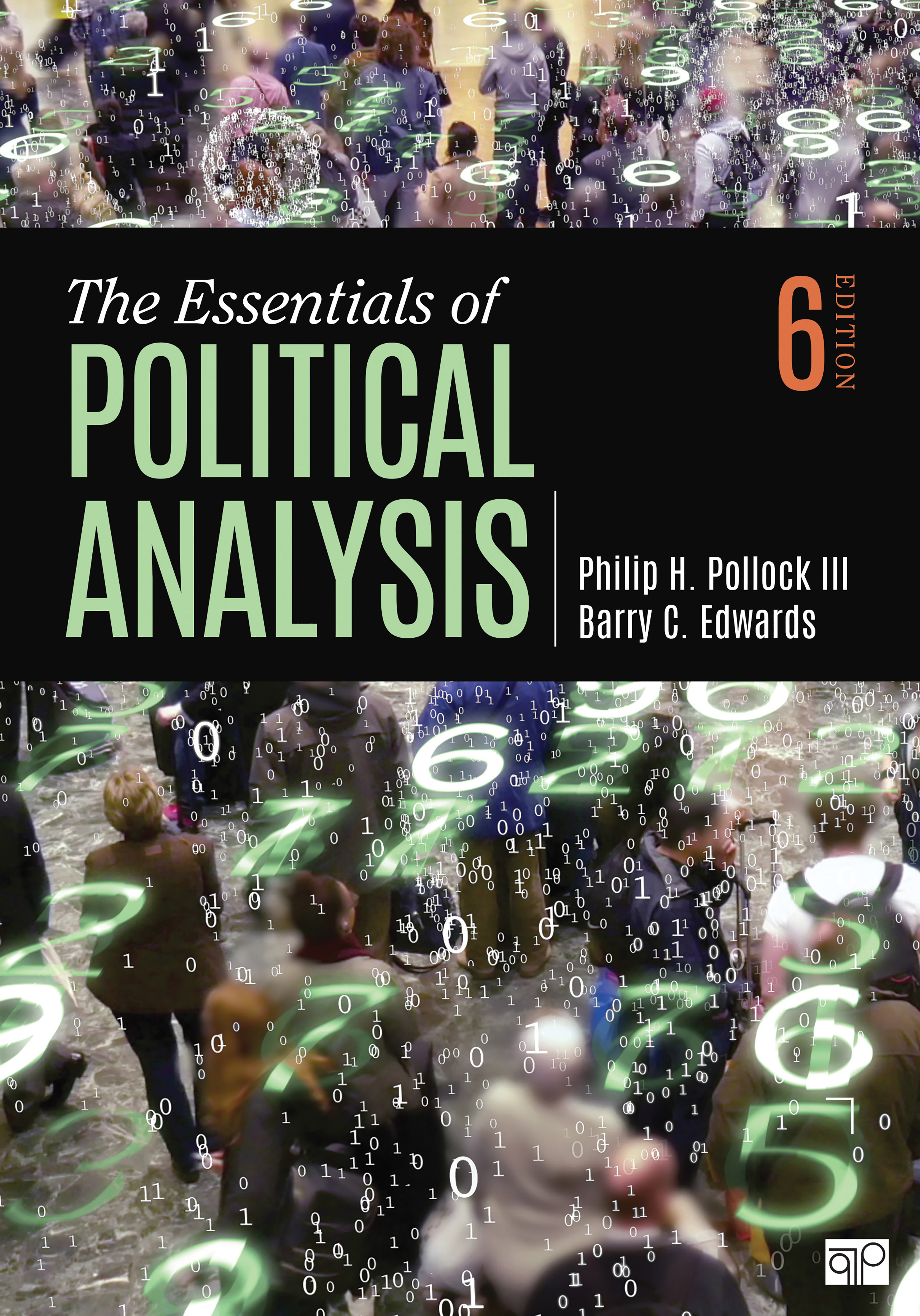
The Essentials of Political Analysis Gain the skills you need to conduct political analysis and critically assess statistical research. In this Sixth Edition of The Essentials of Political Science, bestselling authors Philip H. Pollock III and Barry C. Edwards build your analytic abilities and develop your statistical reasoning with new data, fresh exercises, and accessible examples. This brief, accessible guide walks you through the essentials—measuring concepts, formulating and testing hypotheses, describing variables—while using key terms, chapter-opening objectives, over 80 tables and figures, and practical exercises to get you using and applying your new skills. POLITICAL SCIENCE,General
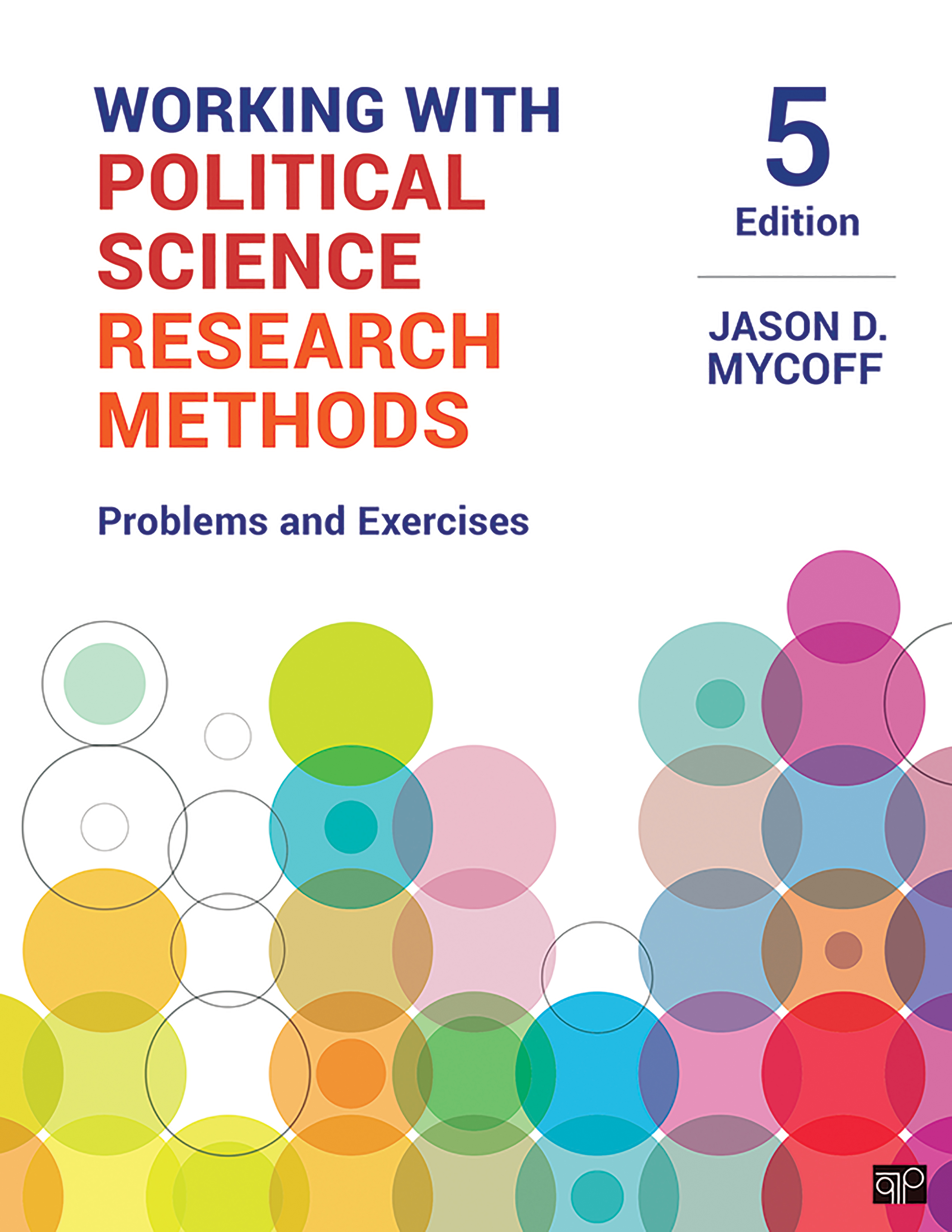
Working with Political Science Research Methods Practice makes perfect. This new, Fifth Edition of Working with Political Science Research Methods continues to support student learning by offering the perfect opportunity to practice each of the methods presented in the core text. Designed to be paired with the Political Science Research Methods 9th edition chapter-for-chapter, the workbook breaks out each aspect of the research process into manageable parts and features new exercises and updated data sets. More than half of the book's exercises are new or updated and feature more international examples, greater focus on qualitative research methods, and directly correlates with the text's more condensed layout. A solutions manual with answers to the workbook is available to adopters. POLITICAL SCIENCE,General
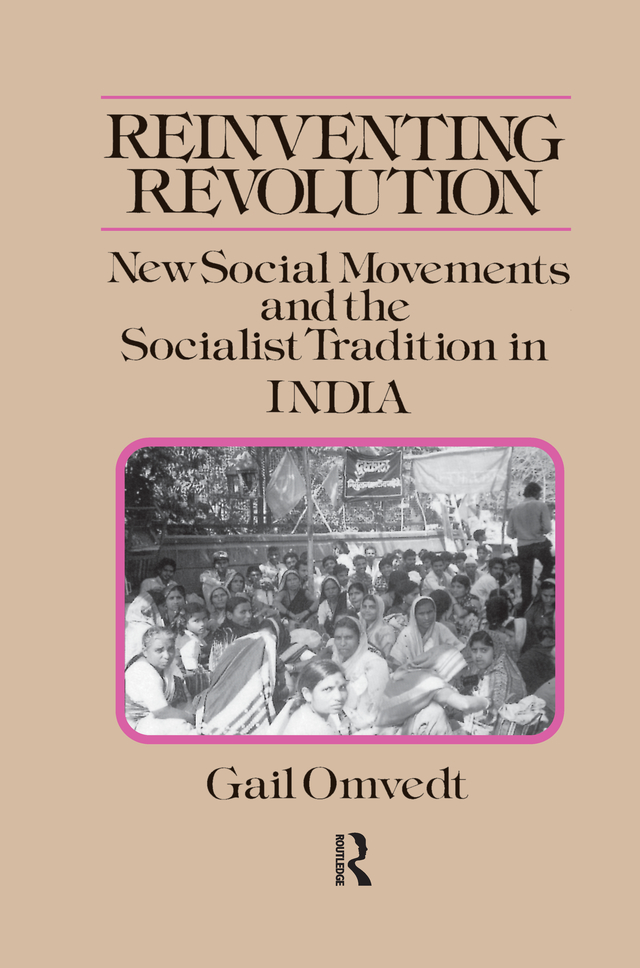
Reinventing Revolution This study describes and analyses the new social movements that have arisen in India over the past two decades, in particular the anti-caste movement (of both the untouchables and the lower-middle castes), the women's liberation movement, the farmers' movement (centred on struggles arising out of their integration into a state-controlled capitalist market), and the environmental movements (opposition to destructive development, including resistance to big dam projects and the search for alternatives). Rooted in participant observation, it focuses on the ideologies and self-understanding of the movements themselves. The central themes of this book are the origin of movements in the socio-economic contradictions of post-independence India; their effect on political developments, in particular the disintegration of Congress hegemony; their relation to "traditional Marxist" theory and Communist practice; and their groping toward a synthesis of theory and practice that constitutes a new social vision distinct from traditional Marxism. POLITICAL SCIENCE,General

Politics Stimulating, succinct and accessible, the fully revised and updated fourth edition of this highly successful text offers a truly comprehensive introduction to the study of politics, written from an international perspective. POLITICAL SCIENCE,General
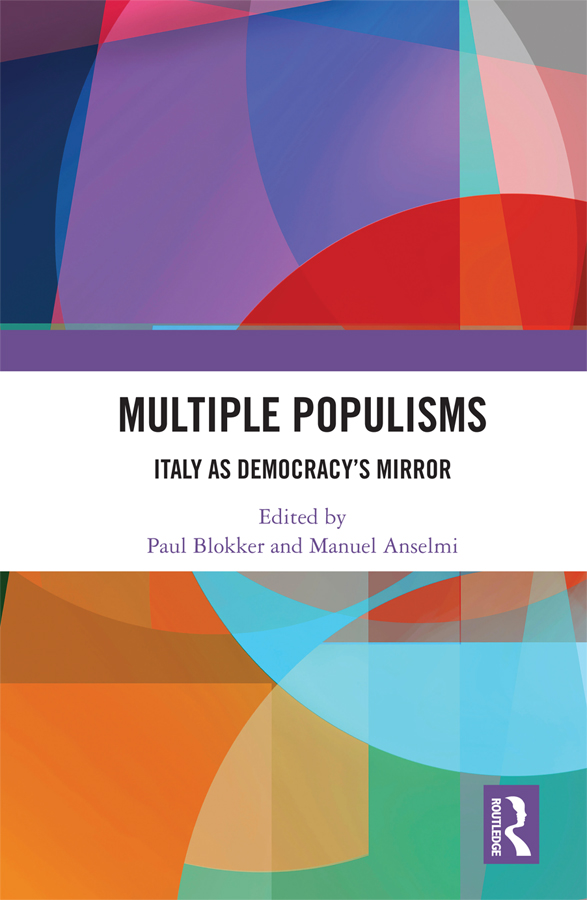
Multiple Populisms This book provides a comprehensive interpretation of the multiple manifestations of populism using Italy, the only country amongst consolidated constitutional democracies in which populist political forces have been in government on various occasions since the early 1990s, as the starting point and benchmark. Populism is a complex, multi-faceted political phenomenon which redefines many of the essential characteristics of democracy; participation, representation, and political conflict. This book considers contemporary versions of populism that pose a real challenge to representative and constitutional democracy. Contributors provide an integrative interpretation of populism and analyse its principal historical, social and politico-legal variables to provide a multi-dimensional reflection on the concept of populism, comprehensive analysis of the populist phenomenon and a theoretical and comparative perspective on the diverse political experiences of populism. Based on conceptual and interdisciplinary reflections from expert authors, this book will be of great interest to scholars and post-graduate students of cultural studies, European studies, political sociology, political science, comparative politics, political philosophy, and political theory with an interest in a comparative and interdisciplinary theory of populism and its manifestations. POLITICAL SCIENCE,General
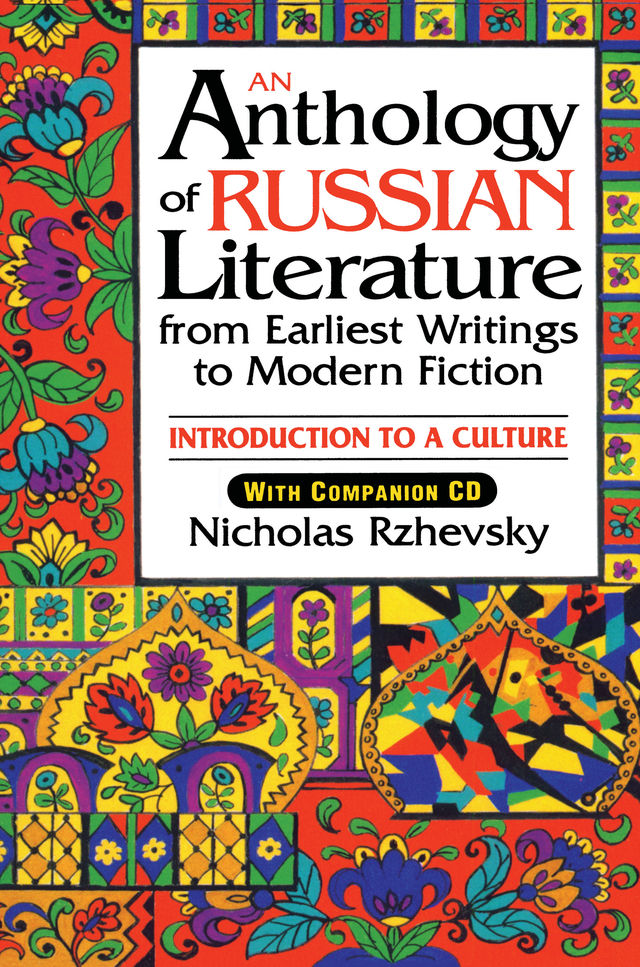
An Anthology of Russian Literature from Earliest Writings to Modern Fiction Russia has a rich, huge, unwieldy cultural tradition. How to grasp it? This classroom reader is designed to respond to that problem. The literary works selected for inclusion in this anthology introduce the core cultural and historic themes of Russia's civilisation. Each text has resonance throughout the arts - in Rublev's icons, Meyerhold's theatre, Mousorgsky's operas, Prokofiev's symphonies, Fokine's choreography and Kandinsky's paintings. This material is supported by introductions, helpful annotations and bibliographies of resources in all media. The reader is intended for use in courses in Russian literature, culture and civilisation, as well as comparative literature. POLITICAL SCIENCE,General
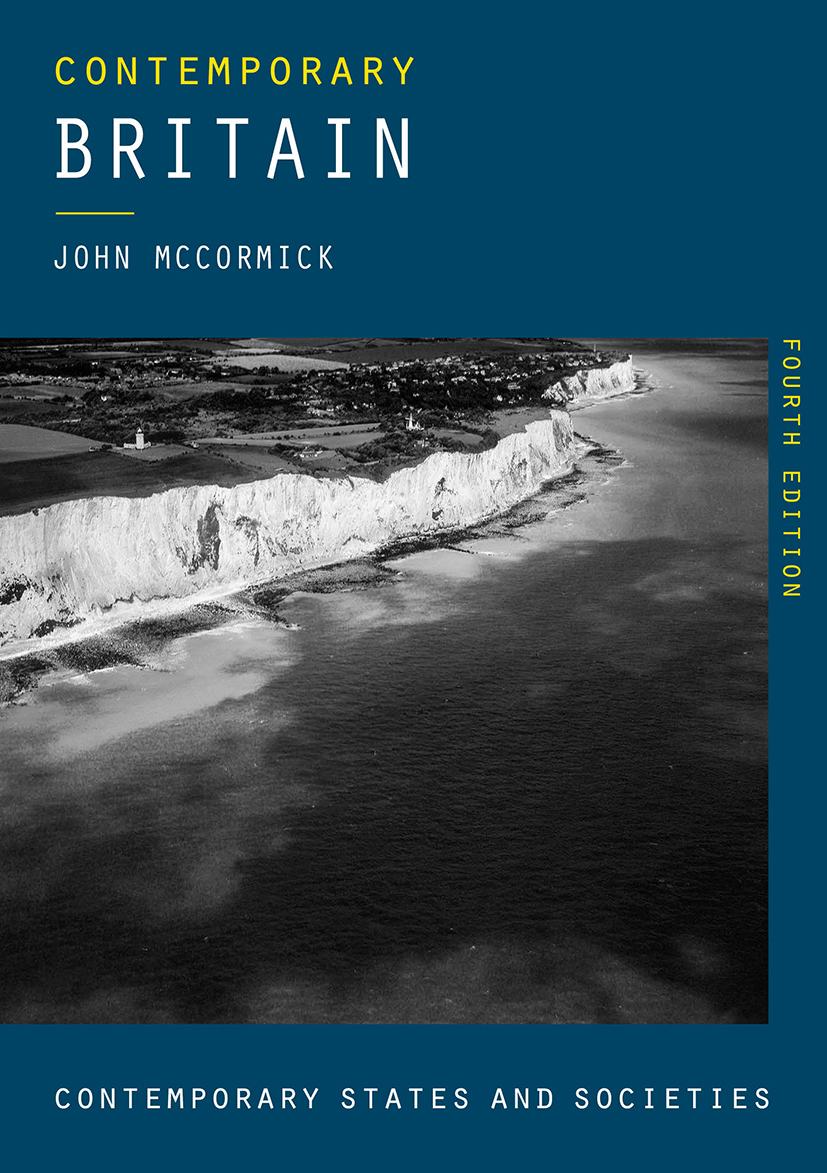
Contemporary Britain A new edition of a popular introduction to all aspects of life in Britain. This version reflects on the ongoing fallout from the global financial and eurozone crises; the May 2015 General Election; the September 2014 referendum on Scottish independence; the new tone of debate on immigration; and the June 2016 referendum on Britain's EU membership. POLITICAL SCIENCE,General

Research Design in Political Science This is a comprehensive introduction to research design for university students at all levels across the whole range of political science, including international relations and public administration. It covers the key steps in the research process and explains the logic and detail of a variety of classic and cutting-edge methods. Based on a pluralistic approach, the text endorses both quantitative and qualitative research methodologies, and outlines the strengths and limitations of different designs for addressing particular research goals. Giving accessible and practical advice, without use of mathematical formulas or formalized notation, this clear and engaging book features many examples of real political science research, and will enable readers to design their own research projects as well as to critically evaluate existing research in the social sciences. POLITICAL SCIENCE,General

Conflict, Security and Justice This path-breaking new textbook provides a broad overview of the core concepts, actors and activities involved in building security and justice after conflict, as well as challenges and lessons learned in this field. Drawing attention to the principles which guide – or should guide – this kind of work, as well as using practical examples throughout, the book covers a uniquely wide range of issues in peacebuilding – from transitional justice and disarmament to security sector reform and human rights. It concludes by considering both the regional and more far-reaching impacts of conflict, including such global phenomena as terrorism, piracy and organised crime. With a decade of experience working in post-conflict zones for the UN and other organisations, and a further ten years in academia and as a consultant for various international organisations, the author’s unparalleled expertise on the topic and her accessible writing style make this book the essential guide to postgraduate and upper-level undergraduate courses on peace and conflict studies. The text is also important supplemental reading for those studying war, peace, development, security or IR in a wider context and for practitioners and policy-makers in the field of peacebuilding. POLITICAL SCIENCE,General
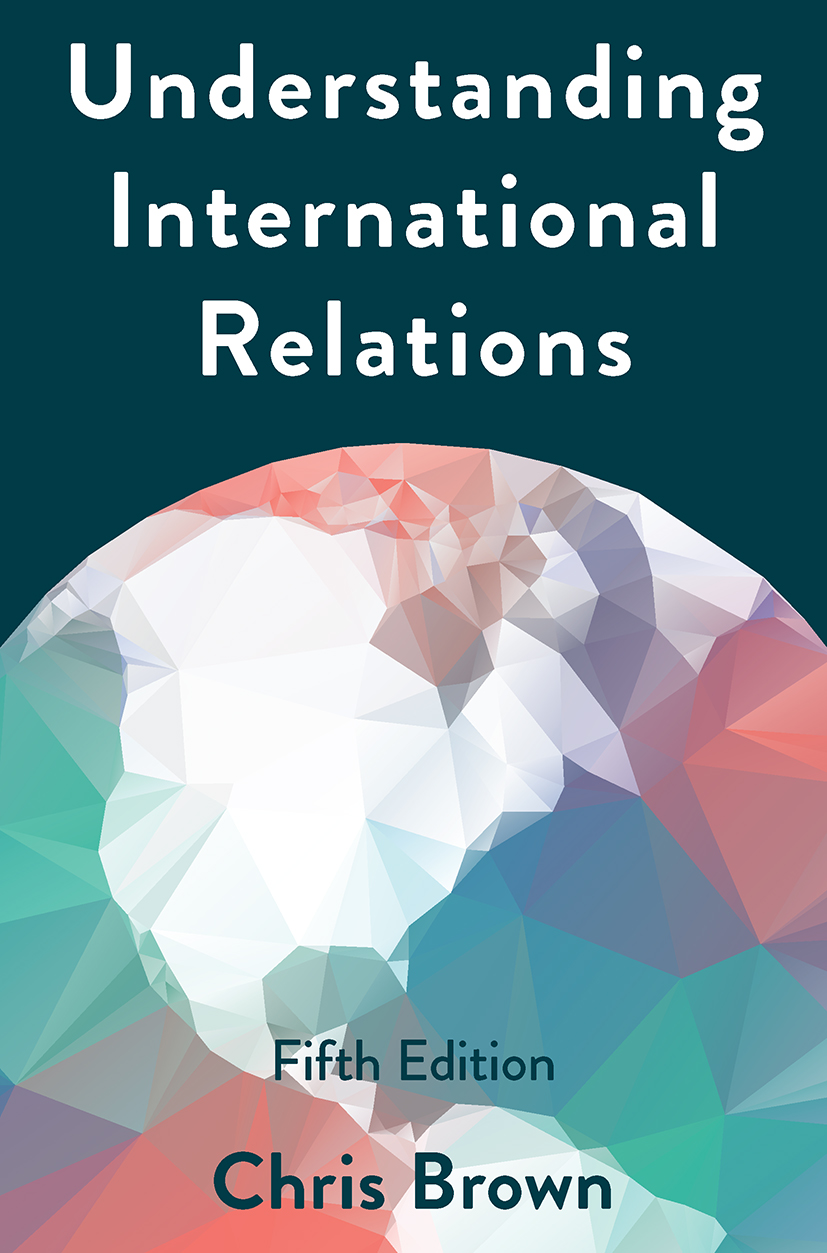
Understanding International Relations The fifth edition of this bestselling textbook offers a comprehensive and engaging introduction to International relations and has been fully updated to cover the dramatic changes in recent world politics. Written in the author’s unique and engaging style, the text explores everything from foreign policy and security to global governance and the global economy, to show how the theories and concepts Brown outlines are the only way to make sense of contemporary issues and events. With reference to such diverse events as Brexit, the Russian armed conflict in Ukraine, the financial crisis, the rise of China, and the challenges of identity politics, the author expertly shows how the range of theories presented in the book allow for an understanding of the destabilising events and developments that characterise global politics today, and will continue to do so in the future. This text remains the definitive guide to understanding international relations, and is suitable for undergraduate and postgraduate students of international relations at any stage of their studies. POLITICAL SCIENCE,General

Contemporary British Politics The third edition of this leading textbook has been comprehensively updated and substantially revised to provide the first definitive introduction to British politics and government under New Labour. As well as according greater attention to the growing role of the European Union in British politics, this edition contains systematic comparisons between constitutional arrangements in the United Kingdom and in other leading democratic political systems. The book has been substantially redesigned with the addition of many new features. POLITICAL SCIENCE,General
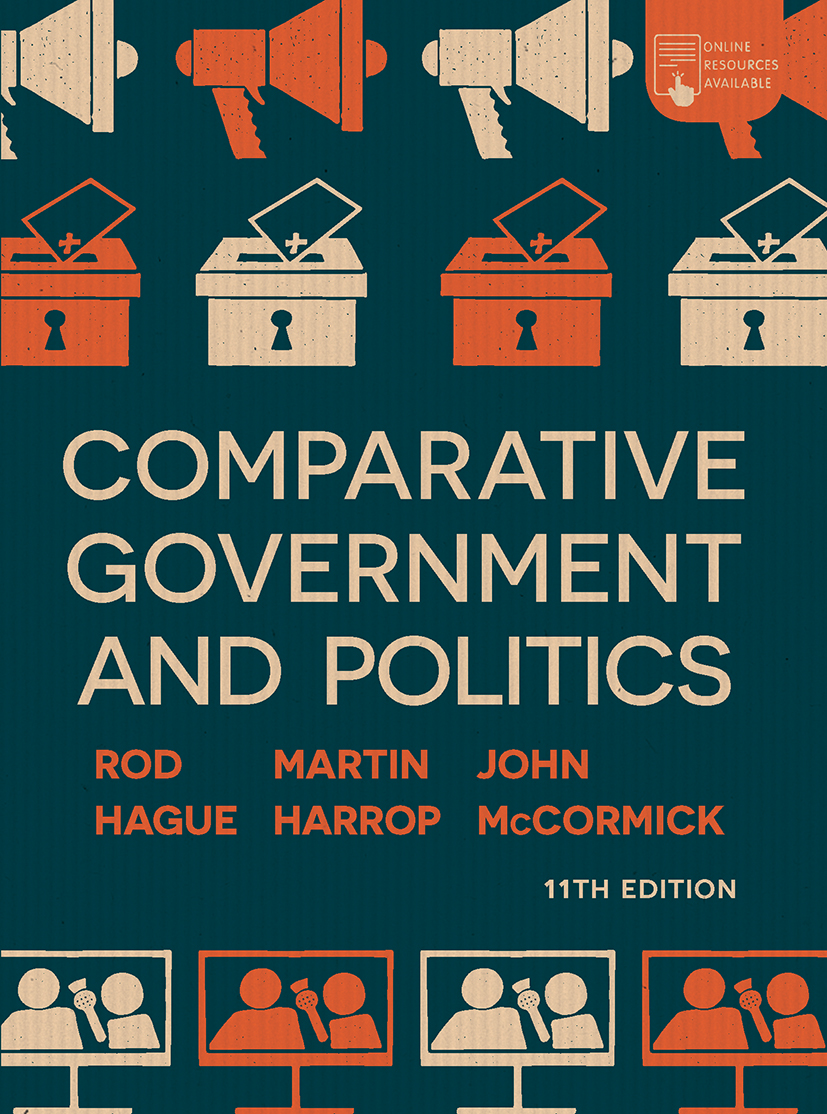
Comparative Government and Politics This tenth edition has been thoroughly revised and updated and sees the addition of a new co-author. Retaining its characteristic clarity of expression and breadth of coverage, it provides a lively account and explanation of the variety of political systems around the world. POLITICAL SCIENCE,General
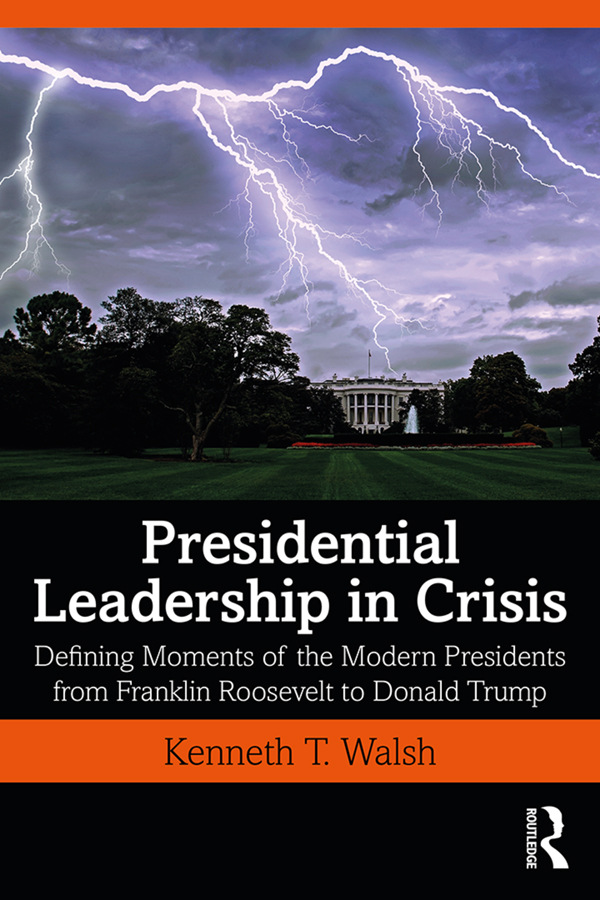
Presidential Leadership in Crisis Crises pose a challenge to leaders beyond any other tests they confront. In this comprehensive and timely book, veteran journalist Kenneth T. Walsh offers a probing look at how presidents from Franklin D. Roosevelt to Donald Trump dealt with crises they faced. Including domestic as well as international issues and assassination attempts, this book stands apart from other accounts of presidents in crisis. Walsh is in search of lessons we can learn, and his findings focus on the presidential attributes and skills that matter most in trying times. This expertly crafted, elegantly written book is appropriate for a variety of college courses and will find its way onto the reading lists of ambitious politicians and interested citizens alike. POLITICAL SCIENCE,General
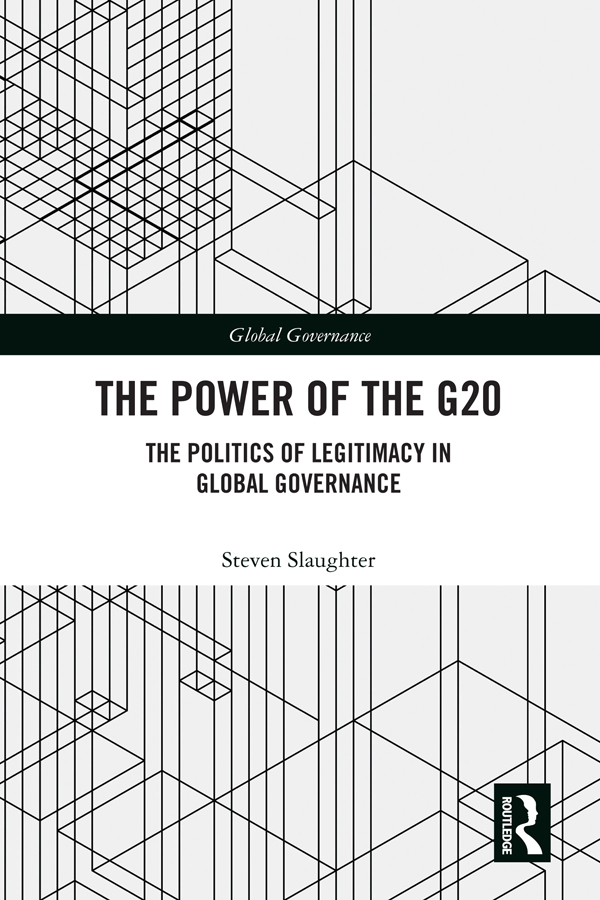
The Power of the G20 Can the power of the G20 be legitimate? This book examines the politics surrounding the G20’s efforts to act effectively and legitimately and the problems and challenges involved in this activity. Developing a critical constructivist conceptualisation of the G20, the book considers holistically and practically the ways that the G20 develops various forms of power and influence and acts as an apex form of global governance that seeks to be an overall coordinating forum to address global problems. Assessing how debates about the legitimacy of the G20 shaped its operation, Slaughter argues that the G20’s power can be legitimate despite a range of considerable challenges and limits. The book also explores what measures the G20 could take to be more legitimate in the future. Offering a direct and accessible consideration of the politics of legitimacy with respect to the G20, this book will be of interest to those attempting to understand and analyse the G20 as well as to scholars of IR theory, global political economy, global policy, diplomacy and globalisation. POLITICAL SCIENCE,General

Politics of Religion This title explores some of the key issues which surround the politics of religion, an area which has historically been the cause of great controversy. Today religion is still the cause of a great deal of political debate, be it the teaching of the creationist theory in the United States or the relationship of church and state in Arabic countries. Four sections present a thorough overview of the politics of religion in historical perspective: Essay chapters written by a variety of academic and other experts on the major world religions and their relationship with politics, and on topics including religious fundamentalism, church and state and religious terrorism, providing background analysis of the links between religion and politics. A – Z glossary of religions, religious groups, ideas and issues, including entries on Agnosticism, Bradford Council of Mosques, Muslim Brotherhood, Nirvana, the World Council of Churches, etc. Entries are up-to-date and cross referenced for ease of use, and symbols at the end of each entry denote to which major religion(s) the entry refers. Maps for reference, showing adherents to major religions worldwide, adherents to religions in the Middle East, and adherents to the major sub-types of Christianity. This title offers up-to-date and unbiased information that will provide a wealth of information to students, academics, business people and general researchers. POLITICAL SCIENCE,General
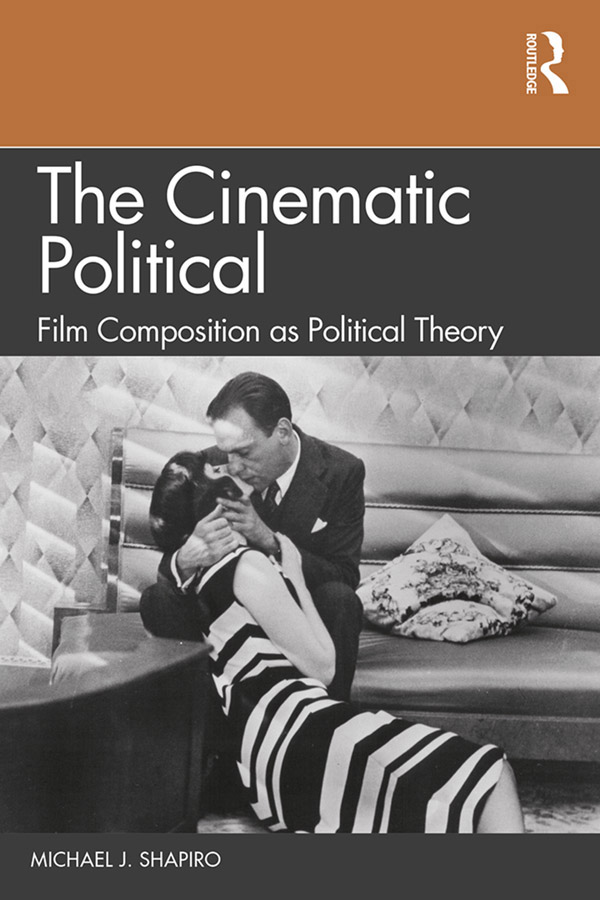
The Cinematic Political In this book, Michael J. Shapiro stages a series of pedagogical encounters between political theory, represented as a compositional challenge, and cinematic texts, emphasizing how to achieve an effective research paper/essay by heeding the compositional strategies of films. The text’s distinctiveness is its focus on the intermediation between two textual genres. It is aimed at providing both a conceptual introduction to the politics of aesthetics and a guide to writing strategies. In its illustrations of encounters between political theory and cinema, the book’s critical edge is its emphasis on how to intervene in cinematic texts with innovative conceptual frames in ways that challenge dominant understandings of life worlds. The Cinematic Political is designed as a teaching resource that introduces students to the relationship between film form and political thinking. With diverse illustrative investigations, the book instructs students on how to watch films with an eye toward writing a research paper in which a film (or set of films) constitutes the textual vehicle for political theorizing. POLITICAL SCIENCE,General

Conspiracy Theories 9/11 was an inside job. The Holocaust is a myth promoted to serve Jewish interests. The shootings at Sandy Hook Elementary School were a false flag operation. Climate change is a hoax perpetrated by the Chinese government. These are all conspiracy theories. A glance online or at bestseller lists reveals how popular some of them are. Even if there is plenty of evidence to disprove them, people persist in propagating them. Why? Philosopher Quassim Cassam explains how conspiracy theories are different from ordinary theories about conspiracies. He argues that conspiracy theories are forms of propaganda and their function is to promote a political agenda. Although conspiracy theories are sometimes defended on the grounds that they uncover evidence of bad behaviour by political leaders, they do much more harm than good, with some resulting in the deaths of large numbers of people. There can be no clearer indication that something has gone wrong with our intellectual and political culture than the fact that conspiracy theories have become mainstream. When they are dangerous, we cannot afford to ignore them. At the same time, refuting them by rational argument is difficult because conspiracy theorists discount or reject evidence that disproves their theories. As conspiracy theories are so often smokescreens for political ends, we need to come up with political as well as intellectual responses if we are to have any hope of defeating them. POLITICAL SCIENCE,General
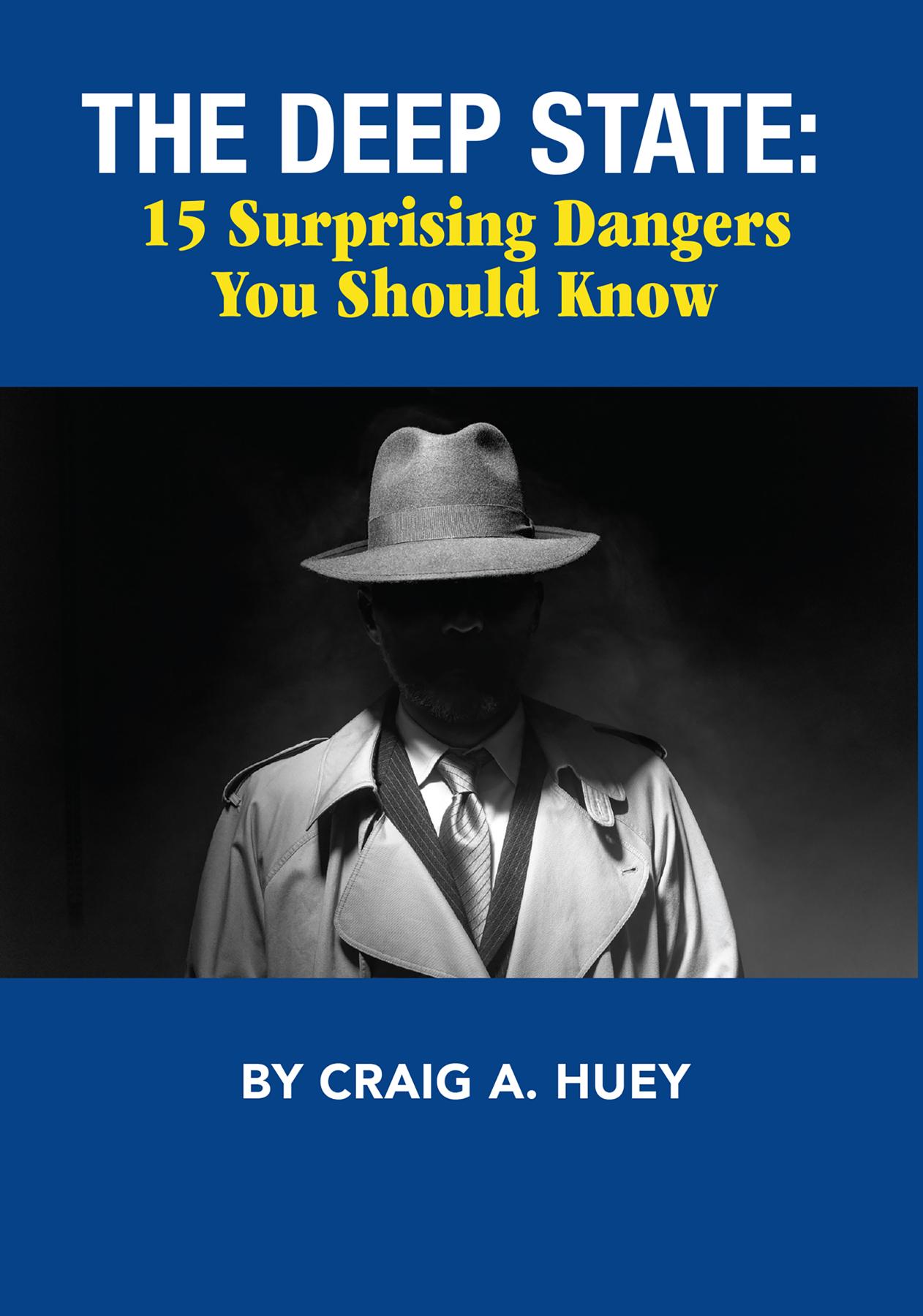
THE DEEP STATE The Deep State. Politicians tell you it's a myth…The media mocks the very idea…And bureaucrats deny its existence. Here's the shocking truth: They deny the Deep State exists because they are the Deep State. And, their primary goals are to: - Grow bigger—expanding their power at the expense of your freedom- Advance their ideology in every part of our society- And resist anyone or anything that disagrees with their own agenda The Deep State begins with a decentralized network at all levels of the state, local and federal government … into the private sector. But its corrupt reach and influence stretch far beyond the government… In The Deep State: 15 Surprising Dangers You Should Know, television commentator, author and small business owner Craig Huey reveals the little-known but powerful influence of this ideological stronghold over our entire nation … our culture … and even what our children are learning in school. You'll be horrified to learn: - How the intelligence agencies have become weaponized for political purposes- 8 government agencies where Deep State influence has escalated to a totalitarian, anti-democratic resistance movement- How members of the "bloated bureaucracy" are promoting the Deep State (and getting paid hundreds of thousands to do it)- The Deep State's #1 most powerful tool to promote their ideological agenda — established under the Obama administration- And more… And, you'll learn how to fight back and take a stand for your freedoms and values — before they are systematically destroyed by the Deep State. POLITICAL SCIENCE,General
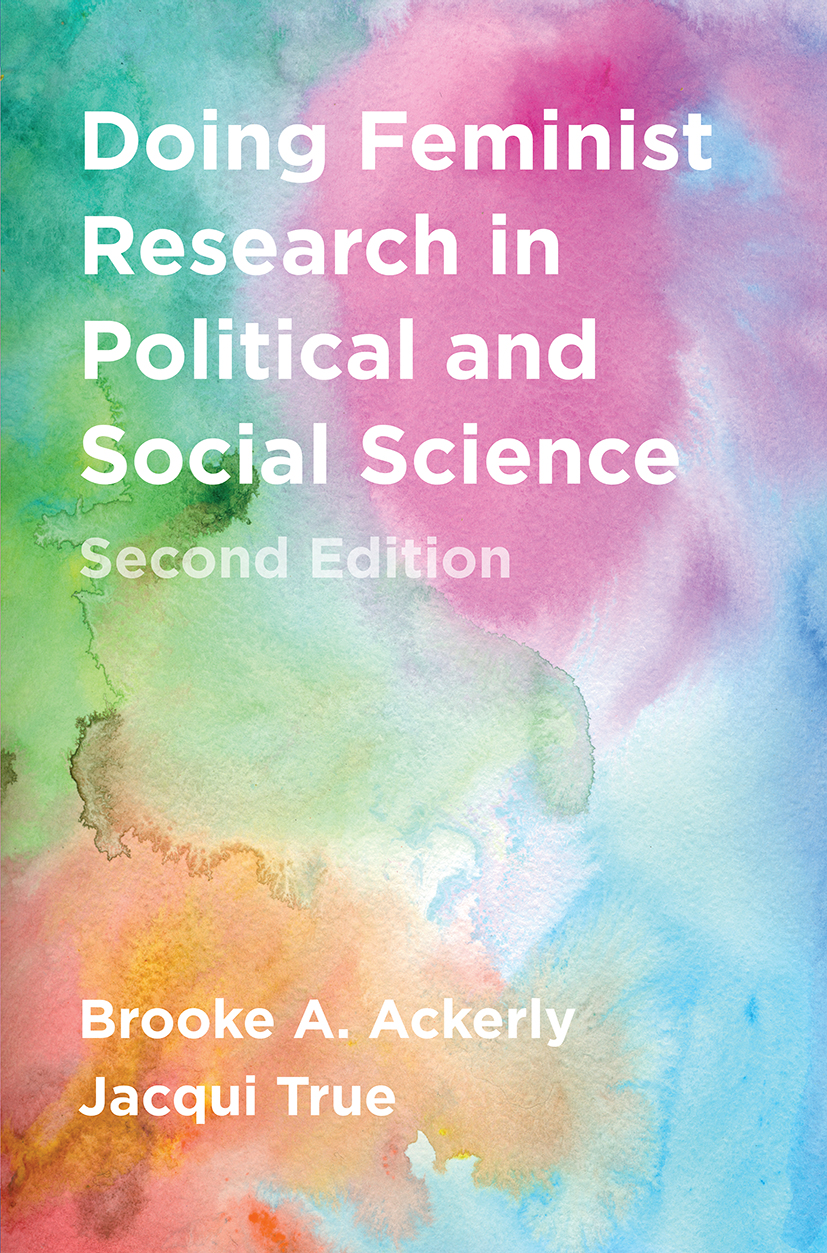
Doing Feminist Research in Political and Social Science Guiding students step-by-step through the research process while simultaneously introducing a range of debates, challenges and tools that feminist scholars use, the second edition of this popular textbook provides a vital resource to those students and researchers approaching their studies from a feminist perspective. Interdisciplinary in its approach, the book covers everything from research design, analysis and presentation, to formulating research questions, data collection and publishing research. Offering the most comprehensive and practical guide to the subject available, the text is now also fully updated to take account of recent developments in the field, including participatory action research, new technologies and methods for working with big data and social media. Doing Feminist Research is required reading for undergraduate and postgraduate courses taking a feminist approach to Social Science Methodology, Research Design and Methods. It is the ideal guide for all students and scholars carrying out feminist research, whether in the fields of International Relations, Political Science, Interdisciplinary International and Global Studies, Development Studies or Gender and Women’s Studies. POLITICAL SCIENCE,General
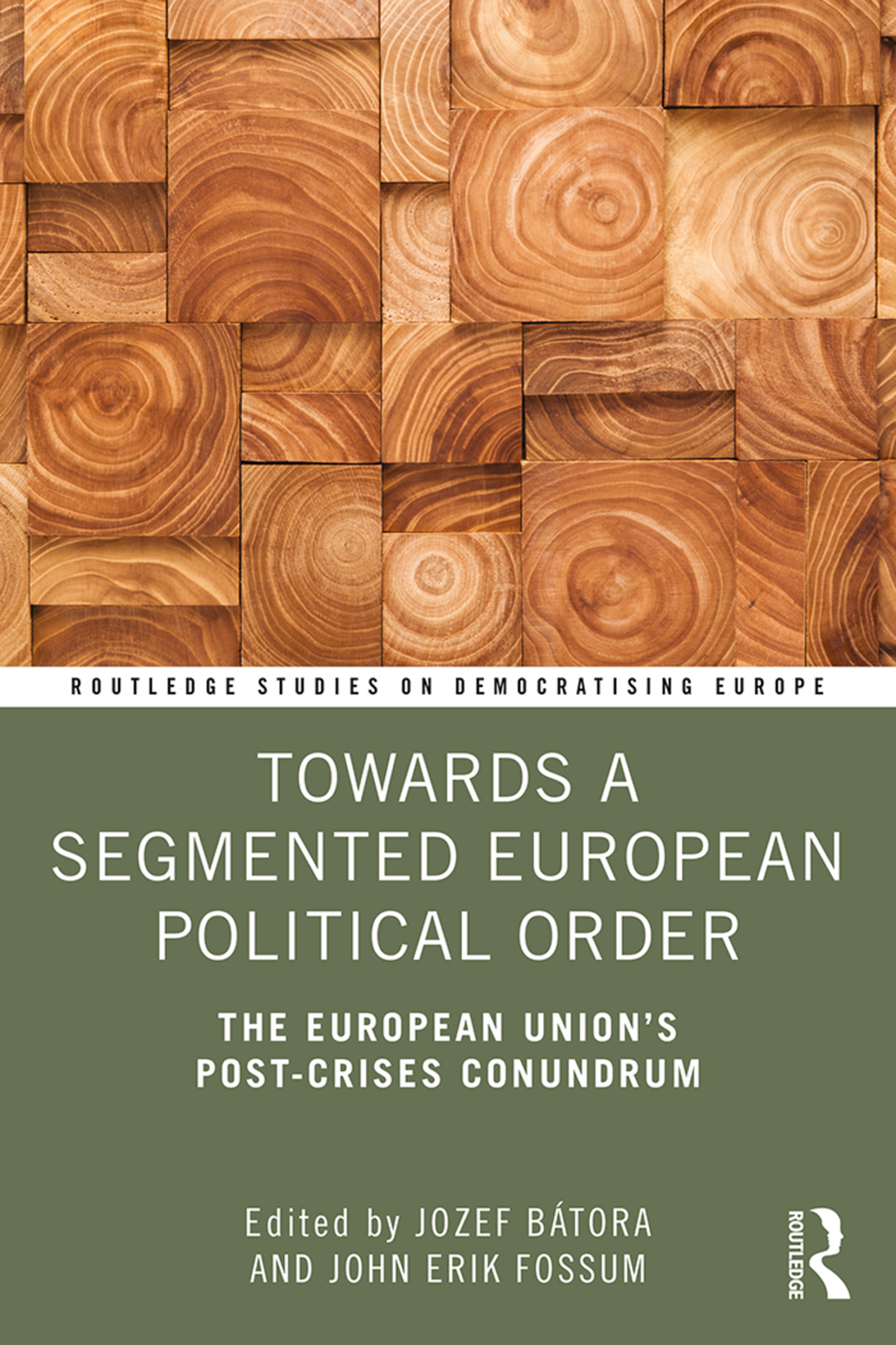
Towards a Segmented European Political Order This book makes a distinctive contribution to the crucial debate on the European Union (EU)’s present and future development. It systematically examines how the range of crises and challenges over the last decade have transformed the EU and relates those findings to the discussion of an increasingly differentiated EU. It argues that the post-crises EU shows clear signs of becoming a segmented political order with in-built biases and constraints. The book spells out the key features of such an order in ideational and structural terms and shows how it more concretely manifests itself in the EU’s institutional and constitutional make-up and in how member states constrain and condition EU action. Different states impose different types of constraints, as is underlined through paying explicit attention to the Visegrád countries. This book will be of key interest to scholars and students of EU politics/studies, European integration and politics, East European politics and foreign policy. POLITICAL SCIENCE,General

War and Peacekeeping There are no winners in war, only losers. We have so far avoided a third world war, but across the globe regional conflicts flare up in a seemingly unstoppable cycle. Who can stand between the armed camps? Over six decades, Martin Bell has stood in eighteen war zones – as a soldier, a reporter and a UNICEF ambassador. Now he looks back on our efforts to keep the peace since the end of the Second World War and the birth of the United Nations peacekeeping mission in the new State of Israel. From the failures of Bosnia, Rwanda and South Sudan to nationalism’s resurgence and the distribution of alternative facts across a darkening political landscape, Bell calls for us to learn from past mistakes – before it’s too late. POLITICAL SCIENCE,General
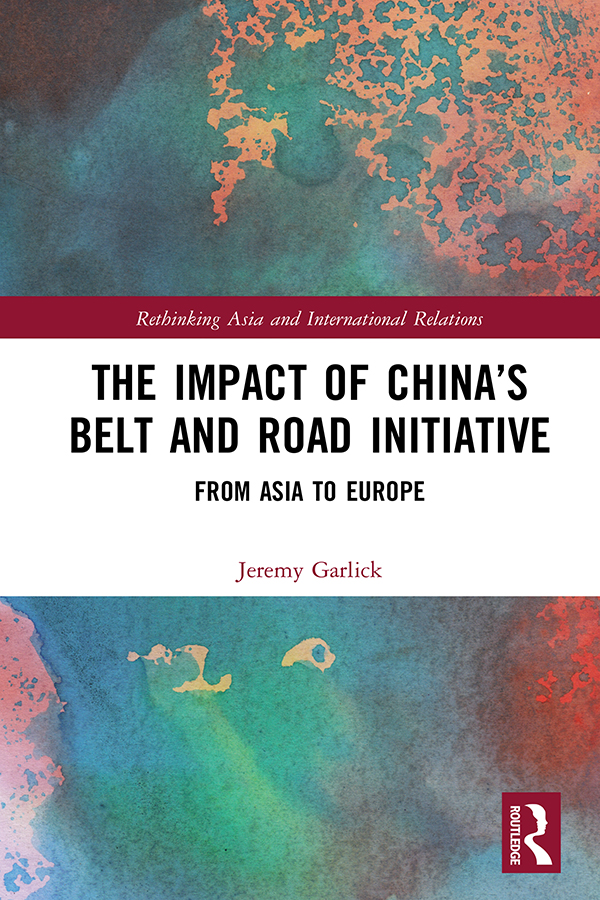
The Impact of China’s Belt and Road Initiative This book merges macro- and micro-level analysis of the Belt and Road Initiative (BRI) to dissect China’s aim in creating an integrated Eurasian continent through this single mega-project. BRI has been the source of much interest and confusion, as established frameworks of analysis seek to understand China’s intentions behind the policy. China’s international activity in the early 21st century has not yet been successfully theorised by IR scholars because of a failure to satisfactorily encompass its complexity. In addition, the mix-and-match syncretism of the Chinese approach to foreign policy has been under-emphasised or omitted in many analyses. Bringing together complexity thinking and analytic eclecticism to assess the degree to which this scheme can transform international relations, Garlick critically examines this large-scale interconnectivity project and its potential impacts. The book will be of interest to scholars and practitioners in the field of international relations and China studies including academics, policy-makers and diplomats around the world. POLITICAL SCIENCE,General
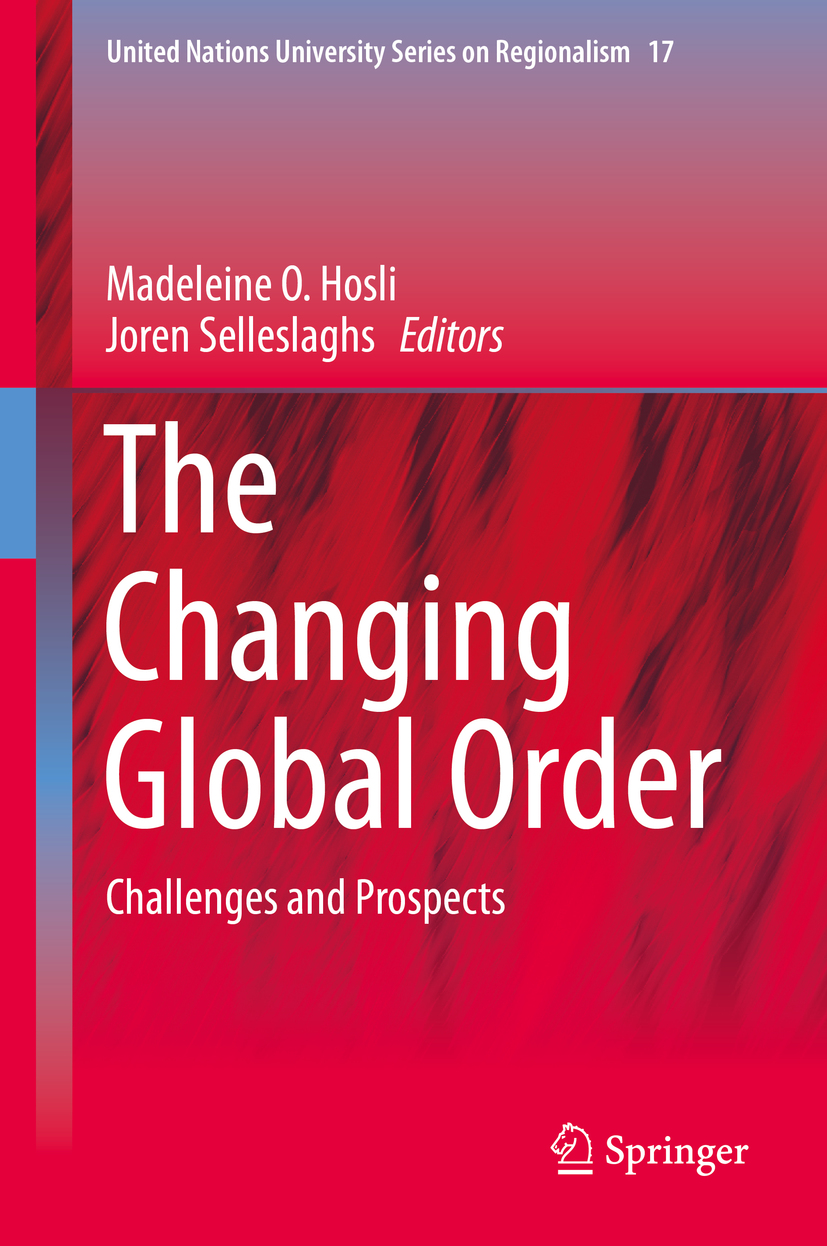
The Changing Global Order This volume offers a comprehensive evaluation of the concept of global order, with a particular emphasis on the role of regional organisations within global governance institutions such as the United Nations. Building from a solid theoretical base it draws upon the expertise of numerous leading international scholars offering a broad array of timely and relevant case studies. These all take into consideration the historical setting, before analysing the contemporary situation and offering suggestions for potential realignments and readjustments that may be witnessed in the future. The volume adopts an interdisciplinary approach when addressing some of the most pressing issues of global governance which our global community must tackle. This presents the readers an opportunity to understand related topics such as political economy, international law, institutions of global governance, in conjunction with the academic field of International Relations (IR). It further helps students and interested readers understand the theoretical and practical foundations to the changing nature of global affairs. POLITICAL SCIENCE,General

The Evolving Relationship between China, the EU and the USA This book closely scrutinizes the individual and collective roles played by China, the EU and the USA in contemporary world politics. Examining the three actors’ respective strategic and policy positions on and behaviour towards the flux of the contemporary global order, the analysis focuses on three major issues and challenges: foreign and security policy; economics and trade; and climate change and energy. Discussing their relative power, as well as their interests, beliefs and positions on a set of decisive issues, this book explores bilateral relations between the three powers and the ways in which they may interact trilaterally in a broader global context to shape international politics. Written by a stellar line-up of experts from the fields of politics and international relations, The Evolving Relationship between China, the EU and the USA will be of huge interest to students and scholars from within these fields, as well as policy-makers and practitioners more generally. POLITICAL SCIENCE,General

Research Methods in Politics and International Relations This is the perfect guide to conducting a research project in politics and international relations from start to finish, from formulating a research question and conducting a literature review to writing up and disseminating your work. POLITICAL SCIENCE,General
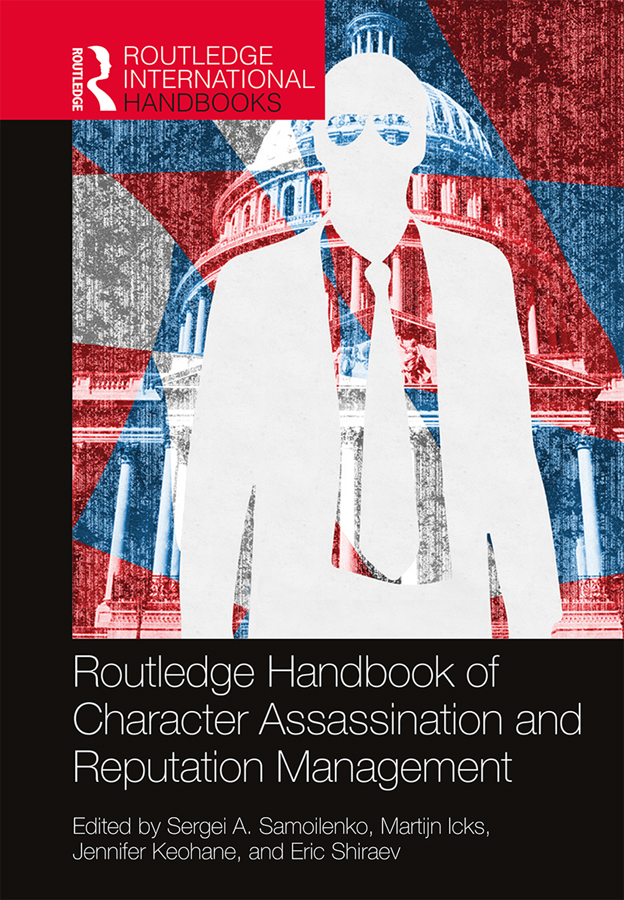
Routledge Handbook of Character Assassination and Reputation Management In modern politics as well as in historical times, character attacks abound. Words and images, like symbolic and psychological weapons, have sullied or destroyed numerous reputations. People mobilize significant material and psychological resources to defend themselves against such attacks. How does character assassination "work," and when does it not? Why do many targets fall so easily when they are under character attack? How can one prevent attacks and defend against them? The Routledge Handbook of Character Assassination and Reputation Management offers the first comprehensive examination of character assassination. Moving beyond studying corporate reputation management and how public figures enact and maintain their reputation, this lively volume offers a framework and cases to help understand, critically analyze, and effectively defend against such attacks. Written by an international and interdisciplinary team of experts, the book begins with a theoretical introduction and extensive description of the "five pillars" of character assassination: (1) the attacker, (2) the target, (3) the media, (4) the public, and (5) the context. The remaining chapters present engaging case studies suitable for class discussion. These include: Roman emperors; Reformation propaganda; the Founding Fathers; defamation in US politics; women politicians; autocratic regimes; European leaders; celebrities; nations; Internet campaigns. This handbook will prove invaluable to undergraduate and postgraduate students in communication, political science, history, sociology, and psychology departments. It will also help researchers become independent, critical, and informed thinkers capable of avoiding the pressure and manipulations of the media. POLITICAL SCIENCE,General

Routledge Handbook of Conspiracy Theories Taking a global and interdisciplinary approach, the Routledge Handbook of Conspiracy Theories provides a comprehensive overview of conspiracy theories as an important social, cultural and political phenomenon in contemporary life. This handbook provides the most complete analysis of the phenomenon to date. It analyses conspiracy theories from a variety of perspectives, using both qualitative and quantitative methods. It maps out the key debates, and includes chapters on the historical origins of conspiracy theories, as well as their political significance in a broad range of countries and regions. Other chapters consider the psychology and the sociology of conspiracy beliefs, in addition to their changing cultural forms, functions and modes of transmission. This handbook examines where conspiracy theories come from, who believes in them and what their consequences are. This book presents an important resource for students and scholars from a range of disciplines interested in the societal and political impact of conspiracy theories, including Area Studies, Anthropology, History, Media and Cultural Studies, Political Science, Psychology and Sociology. POLITICAL SCIENCE,General

Governance, Politics and the State The term 'governance' has become on of the most widely used in debates in Political Science - and one of the most misunderstood and contested. This leading and defining text has been updated throughout and extended to cover netweork, global and multi-level governance, on meta-governance and complexity, measurement and building empirical models. POLITICAL SCIENCE,General
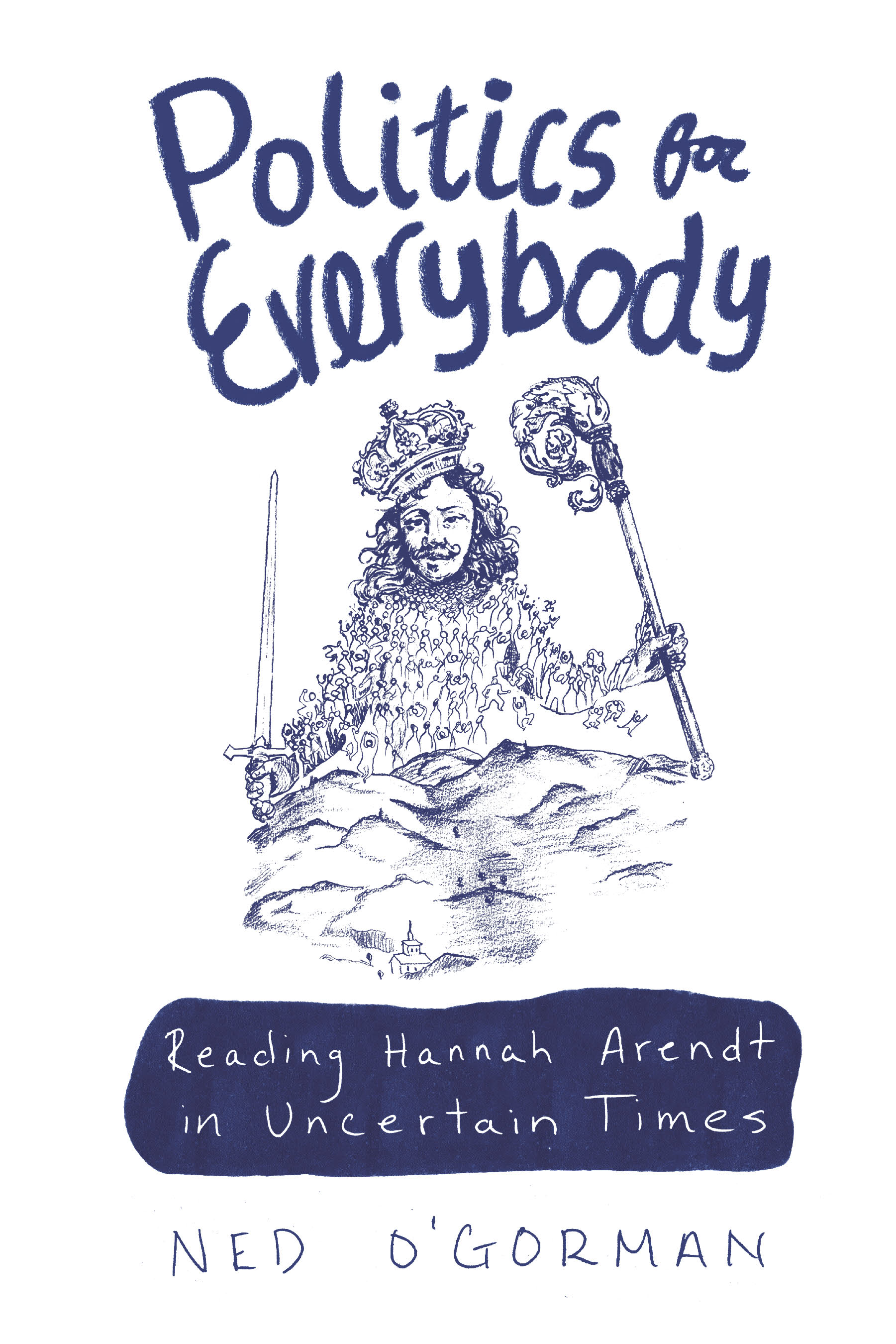
Politics for Everybody In this age of nearly unprecedented partisan rancor, you’d be forgiven for thinking we could all do with a smaller daily dose of politics. In his provocative and sharp book, however, Ned O’Gorman argues just the opposite: Politics for Everybody contends that what we really need to do is engage more deeply with politics, rather than chuck the whole thing out the window. In calling for a purer, more humanistic relationship with politics—one that does justice to the virtues of open, honest exchange—O’Gorman draws on the work of Hannah Arendt (1906–75). As a German-born Jewish thinker who fled the Nazis for the United States, Arendt set out to defend politics from its many detractors along several key lines: the challenge of separating genuine politics from distorted forms; the difficulty of appreciating politics for what it is; the problems of truth and judgment in politics; and the role of persuasion in politics. O’Gorman’s book offers an insightful introduction to Arendt’s ideas for anyone who wants to think more carefully POLITICAL SCIENCE,General

We are the People Recent years have seen a surge of populism across the Western world, exposing the vulnerabilities of liberal democracy and driving the international political agenda to the right. In Germany in 2017 the recently founded far-right populist party—the Alternative for Germany (AfD)—swept into the Bundestag, claiming to be the voice of the people against a corrupt liberal elite and overturning the delicate postwar political consensus in Germany. We are the People analyzes the sudden growth and radicalization of the AfD, from its Euroskeptic beginnings in 2013 to its increasing extremism. Penny Bochum shows us how the leaders’ use of inflammatory, xenophobic, and even Nazi-era language mirrors that of emerging far-right forces across much of the Western world. At the same time, through a lucid examination of the group’s ideology, Bochum shows how their brand of populism is distinct and based on German experiences and history. POLITICAL SCIENCE,General
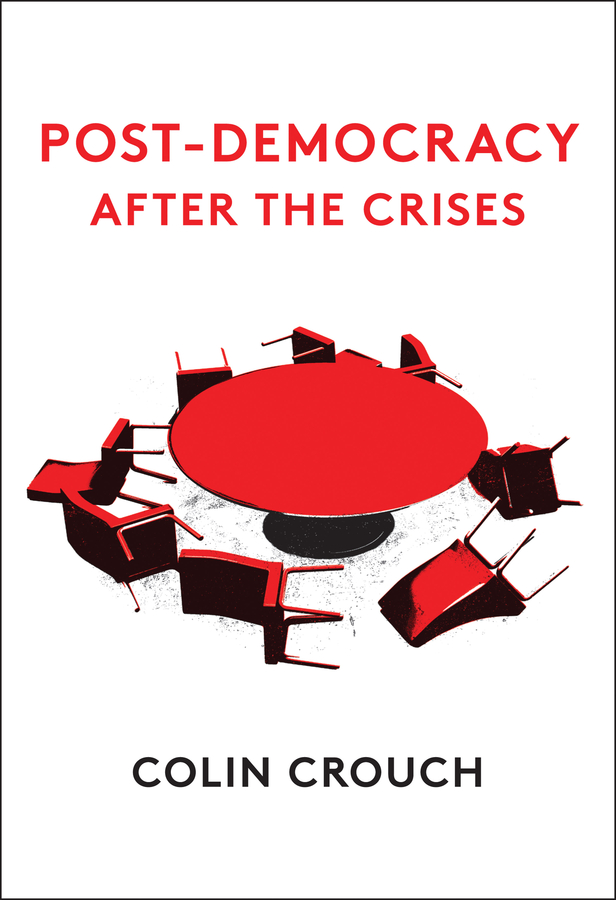
Post-Democracy After the Crises In Post-Democracy (Polity, 2004) Colin Crouch argued that behind the façade of strong institutions, democracy in many advanced societies was being hollowed out, its big events becoming empty rituals as power passed increasingly to circles of wealthy business elites and an ever-more isolated political class. Crouch’s provocative argument has in many ways been vindicated by recent events, but these have also highlighted some weaknesses of the original thesis and shown that the situation today is even worse. The global financial deregulation that was the jewel in the crown of wealthy elite lobbying brought us the financial crisis and helped stimulate xenophobic movements which no longer accept the priority of institutions that safeguard democracy, like the rule of law. The rise of social media has enabled a handful of very rich individuals and institutions to target vast numbers of messages at citizens, giving a false impression of debate that is really stage-managed from a small number of concealed sources. Crouch evaluates the implications of these and other developments for his original thesis, arguing that while much of his thesis remains sound, he had under-estimated the value of institutions which are vital to the support of a democratic order. He also confronts the challenge of populists who seem to echo the complaints of Post-Democracy but whose pessimistic nostalgia brings an anti-democratic brew of hatred, exclusion and violence. POLITICAL SCIENCE,General

Communists and Community Communists and Community seeks to reframe the traditional chronology of the Communist Party in the United States as a means to better understand the change that occurred in community activism in the mid-twentieth century. Ryan Pettengill argues that Popular Front activism continued to flourish throughout the war years and into the postwar period. In Detroit, where there was a critical mass of heavy industry, Communist Party activists mobilized support for civil rights and affordable housing, brought attention to police brutality, sought protection for the foreign-born, and led a movement for world peace. Communists and Community demonstrates that the Communist Party created a social space where activists became effective advocates for the socioeconomic betterment of a multiracial work force. Pettengill uses Detroit as a case study to examine how communist activists and their sympathizers maintained a community to enhance the quality of life for the city’s working class. He investigates the long-term effects of organized labor’s decision to force communists out of the unions and abandon community-based activism. Communists and Community recounts how leftists helped workers, people of color, and other under-represented groups became part of the mainstream citizenry in America. POLITICAL SCIENCE,General

A Collective Pursuit Teachers’ unions are the organizations responsible for safeguarding the conditions of teachers’ employment. Union supporters claim strong synergies between teachers’ interests and students’ interests, but critics of unions insist that the stance of teachers in collective bargaining may disadvantage students as unions reduce the power of administrators to manage, remove, reward or retain excellent teachers. In A Collective Pursuit, Lesley Laveryunpacks how teachers’ unions today are fighting for contracts that allow them to earn a decent living and build “schools all students deserve.†She explains the form and function of the nation’s largest teachers’ unions. Lavery then explores unionization campaigns in the Twin Cities charter schools. A Collective Pursuit also examines teacher strikes and contract negotiations, school finance and finance reform, and district and union attempts to address racial achievement gaps, to provide a context for understanding the economic, political, and demographic forces that inspire teachers to improve conditions for students. A Collective Pursuit emphasizes that while teachers’ unions serve a traditional, economic role, they also provide a vast array of valuable services to students, educators, parents, and community members. POLITICAL SCIENCE,General
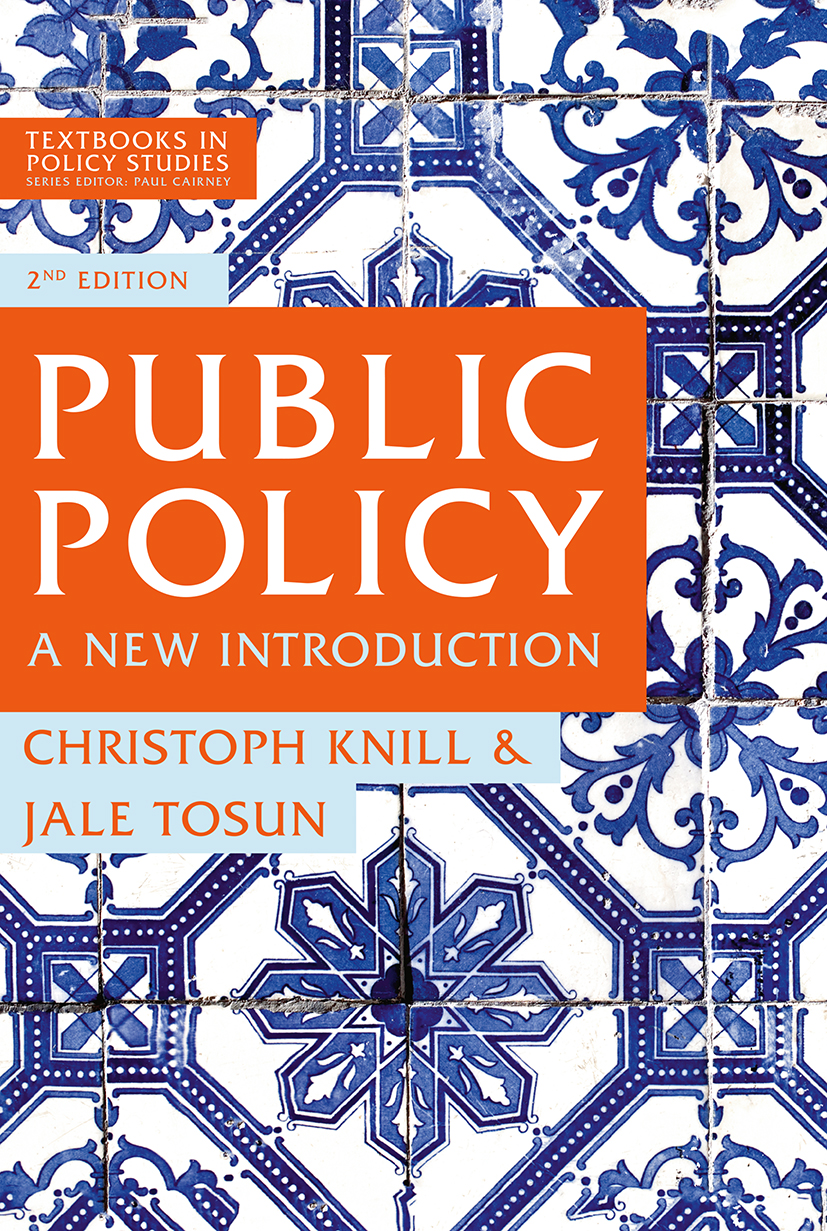
Public Policy A major new introduction to public policy analysis and the changing nature of the policy process. Comprehensive, up-to-date and truly international in scope, it provides accessible but sophisticated coverage of the field taking full account of global and multilevel dimensions and the challenges posed by real-world policy-making for any schematic view of policy cycles. POLITICAL SCIENCE,General

India, Vietnam and the Indo-Pacific This book delves into the examination of bilateral relations between India and Vietnam in the 21st century and how the Indo-Pacific as a geo-political construct lends itself to the improvement of their engagement. With the rise and increasing assertiveness of China, the slow growth of the United States, the resurgence of Japan, and the oscillating role of ASEAN as a multilateral organization, the Indo-Pacific has emerged as a theatre of international geostrategic competition. This book studies these changing geopolitical realities and new evolving strategic configurations, while addressing political, economic, defence, and strategic aspects of the relationship along with the role of China and the US in facilitating ties. India’s Act East Policy that was upgraded from the Look East Policy – one of the main drivers for India’s increasing presence in the Asia-Pacific region – is also examined in this volume. An important intervention in the study of international relations, this book will be indispensable to students and researchers of maritime studies, security studies, politics and international relations, geopolitics, and Asian studies. POLITICAL SCIENCE,General

Africa-Europe Relationships The relationships between Africa and Europe are of high strategic importance. This volume studies the ongoing dynamics between the two continents by adopting a pluralist understanding of international relations which encompasses non-state actors as well as states. Going beyond pure intergovernmentalism, this focus of this book is on activists, business people, religious believers, local politicians as well as transnational networks and by hybrid coalitions. Such plurality of socio-economic and political interactions underpinning the relationship between Africa and Europe is underexamined and yet of great importance. The text identifies new patterns of cooperation and recurrent obstacles in the African-European multistakeholder dynamics, thus opening the way for a more accurate understanding of the future relationship between Africa and Europe. This book brings African and European reflections together, on an equal standing, in order to achieve a true dialogue among civilizations. This book is aimed at all those who are interested in African-European relationships, including students and researchers, as well as activists, business people, civil servant and functionaries at local and national level. POLITICAL SCIENCE,General
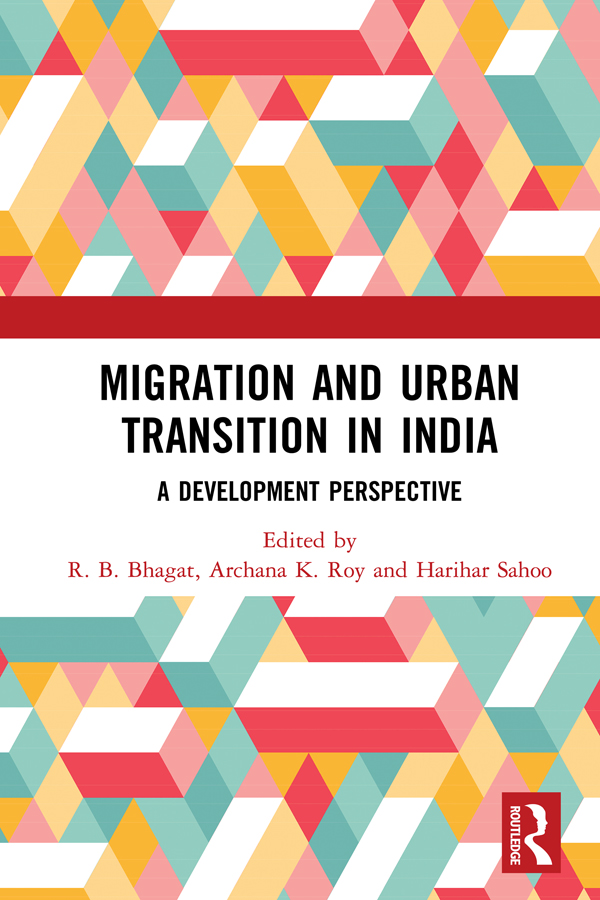
Migration and Urban Transition in India Migration has emerged as an important issue in contemporary global politics and in the discourse around human development. This book highlights the role of migration in socioeconomic development and its interdependence with urbanization, employment, labour and industry. This volume identifies the challenges which migration and the subsequent dynamism in population and spatial parameters pose to land-use patterns, ecology, social politics and international relations. Through a study of migration patterns and trends in different parts of India, this collection analyzes the relationship of migration with social and occupational mobility, poverty and wealth indices, inequality, distribution of resources and demographic change. It also explores policy measures and frameworks which can bring migration into the fold of national development strategies. Timely and comprehensive, the book underscores the importance of migration and urbanization, sustainability and inclusivity to economic growth and development. It will be an essential read for scholars and researchers of migration studies, political studies, sociology, urban studies, development studies and political sociology. POLITICAL SCIENCE,General

Greek-Turkish Relations in an Era of Détente Greek-Turkish conflict-ridden relations have long occupied a problematic position in the Western alliance, first in NATO then, more dramatically, within the context of the newly developing European Union and its defence initiatives. Following three major earthquakes on both sides of the Aegean, the two countries have now experienced, firstly, a public empathy towards each other, and secondly, a significant diplomatic rapprochement. This rapprochement though has failed to resolve the Cyprus conflict, and is now at risk of reverting back to a series of conflicts. This book addresses the crucial issues between Greece and Turkey, from a critical perspective, and provides an up-to-date assessment of the current state of the Greek-Turkish rapprochement and its future development. This book was previously published as a special issue of the journal Turkish Studies. POLITICAL SCIENCE,General
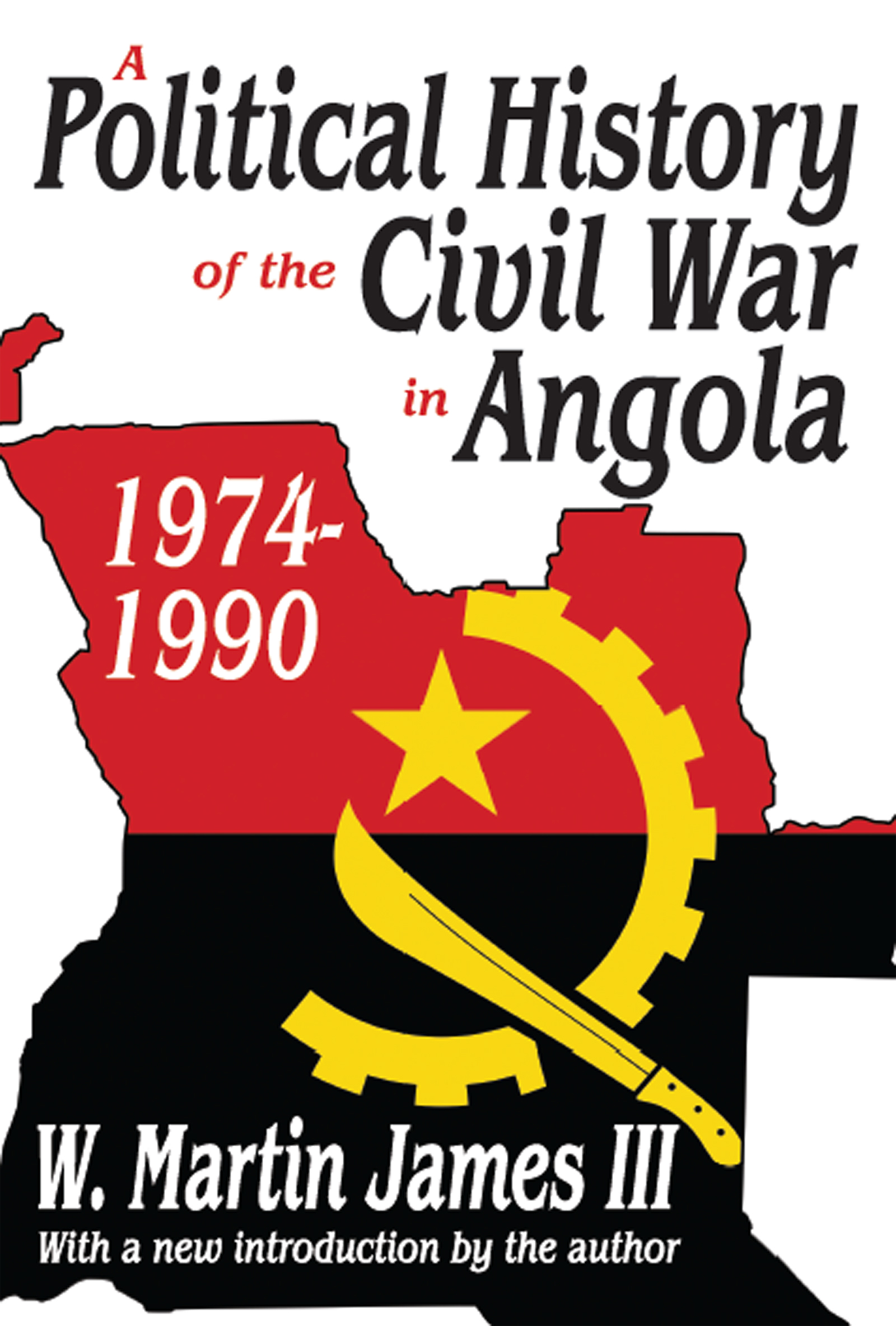
A Political History of the Civil War in Angola, 1974-1990 When Portugal's colonial rule in Angola ended in 1974, three liberation groups-UNITA (National Union for the Total Independence of Angola), FNLA (National Front for the Liberation of Angola), and MPLA (Popular Movement for the Liberation of Angola)-agreed to a tripartite movement for the fledgling nation. Conflicts quickly arose and the MPLA, with Cuban and Soviet assistance, drove its rivals from the capital, instigating a civil war, which continues into three periods (1975-1991, 1992-94, and 1998-2002). This volume covers the first period, focusing on the political history of the UNITA movement and its struggles with the MPLA. The Angolan civil war was the product of personal jealousies, contrasting ideologies, and ethnic animosities. From its inception, the conflict between UNITA and Angola's Marxist government was an international affair involving the U. S., the USSR, China, and many African states: W. Martin James III, who wrote his book near the close of the first period of civil war, contends that despite Gorbachev's "new thinking" and talk of peaceful solutions to regional conflicts, Soviet policy toward Angola marked a reversion to the Brezhnev Doctrine. The biggest MPLA-Cuban offenses occurred during Gorbachev's tenure with Soviet advisers at the brigade level directing an MPLA offensive. American policy toward Angola is also examined here. This is the first book to emphasize the dynamic role of UNITA in the Angolan liberation movement. James acknowledges that the importance of foreign powers in guaranteeing a government of national reconciliation. Just as important are strategies of compromise requiring trust in a political context where it is violated and submission for the common good where defiance is a remnant of the colonial past. Foreign policy analysts, African area specialists, and scholars of post-colonial history find this volume indispensible. POLITICAL SCIENCE,General
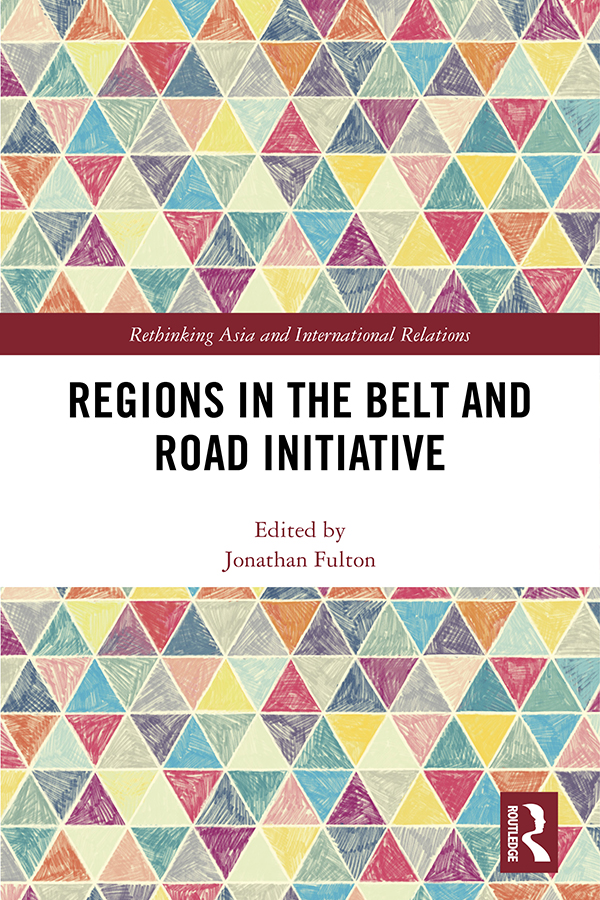
Regions in the Belt and Road Initiative Introduced in 2013, China’s Belt and Road Initiative (BRI) has had a significant impact within Asia and across other regions. This book provides empirical case studies examining the relations between China and the states in specific regional groupings, including South-East Asia, Central Asia, South Asia, the Persian Gulf, the Horn of Africa, and Central/Eastern Europe. At the theoretical level, Buzan and Waever’s work on regional security complexes is used to develop a framework for analyzing the current impact of the BRI and its potential future effects within these regions, while the case studies explore the extent to which different International Relations and International Political Economy theories explain change in these relationships as the regional security environment shifts. The contributors address questions as diverse as the domestic political and economic drivers impacting the level of BRI cooperation; the effects of cooperation with the US; as well as the historical political and economic risk considerations for China in pursuing BRI cooperation; and the motivations of regional responses to the BRI and rivalries and variations in those responses. This book will be of interest to academics working in the fields of Chinese foreign policy, International Relations, International Political Economy, and area studies. Professionals in the corporate world and Governmental practitioners and non-government agencies will also find the contributions useful. POLITICAL SCIENCE,General
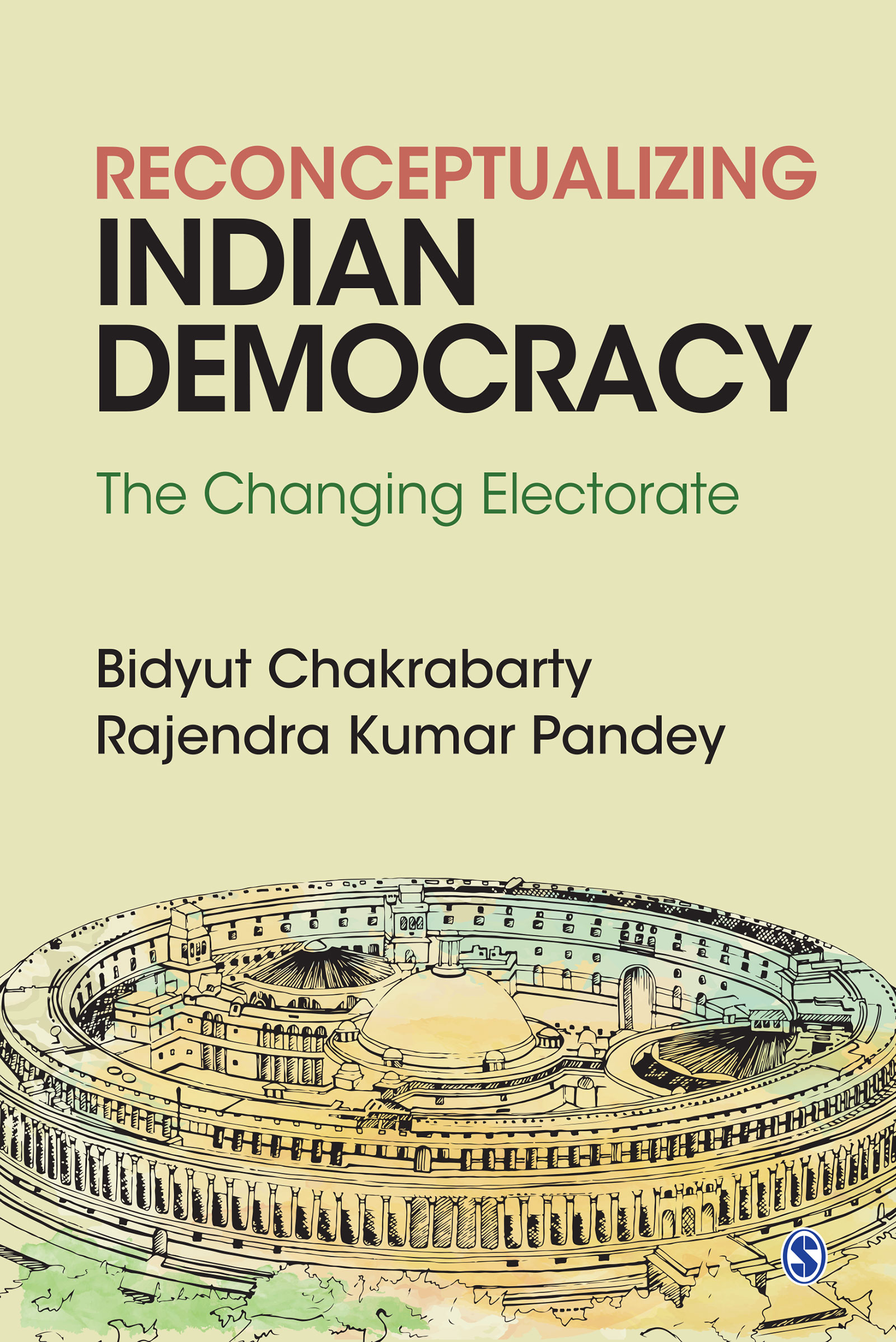
Reconceptualizing Indian Democracy A comprehensive analysis of election data, drawing out trends and reconceptualizing Indian democracy in theoretical terms. POLITICAL SCIENCE,General

Hitting First The U.S. war in Iraq was not only an intelligence failure—it was a failure in democratic discourse. Hitting First offers a critical analysis of the political dialogue leading up to the American embrace of preventive war as national policy and as the rationale for the invasion and occupation of Iraq. Taking as its point of departure the important distinction between preemptive and preventive war, the contributors examine how the rhetoric of policy makers conflated these two very different concepts until the public could no longer effectively distinguish between a war of necessity and a war of choice. Although the book focuses on recent events, Hitting First takes into consideration the broader historical, ethical, and legal context of current American policies. Precedents are examined for preventive military action based on conventional as well as nuclear, biological, and chemical weapons threats. The authors also consider recent examples of the rhetoric of “humanitarian intervention,†which have tended to undermine traditional notions of national sovereignty, making purportedly “morally justifiable†actions easier to entertain. Intelligence gathering and its use, manipulation, and distortion to suit policy agendas are also analyzed, as are the realities of the application of military force, military requirements to sustain a policy of preventive war, and post-conflict reconstruction. Hitting First presents a timely and essential view of the lessons learned from the failures of the Iraqi conflict, and offers a framework for avoiding future policy breakdowns through a process of deliberative public and governmental debate within a free market of ideas. The critiques and prescriptions offered here provide a unique and valuable perspective on the challenges of formulating and conduct of national security policy while sustaining the principles and institutions of American democracy. This collection will appeal to students and scholars of American foreign policy, international relations, political communication, and ethics. POLITICAL SCIENCE,General
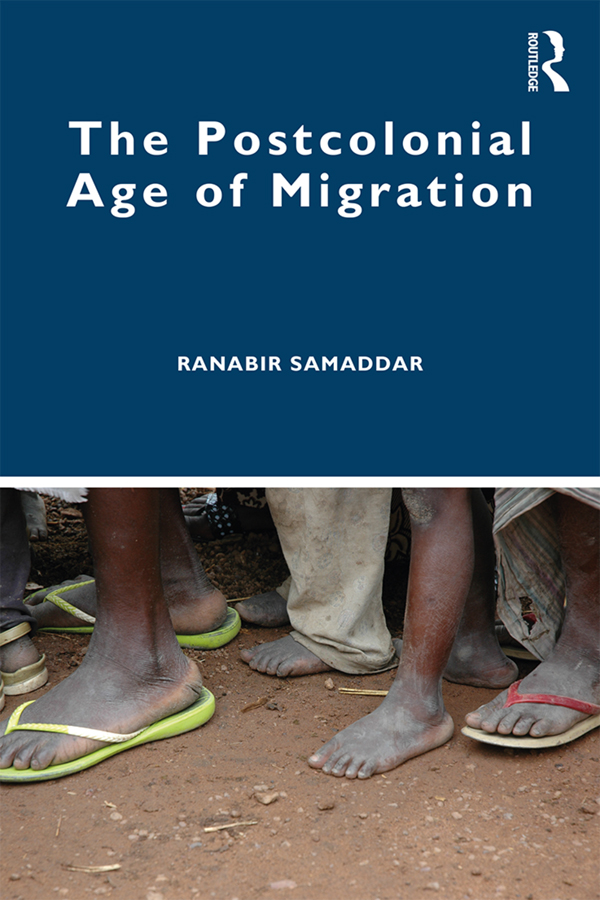
The Postcolonial Age of Migration This book critically examines the question of migration that appears at the intersection of global neo-liberal transformation, postcolonial politics, and economy. It analyses the specific ways in which colonial relations are produced and reproduced in global migratory flows and their consequences for labour, human rights, and social justice. The postcolonial age of migration not only indicates a geopolitical and geo-economic division of the globe between countries of the North and those of the South marked by massive and mixed population flows from the latter to the former, but also the production of these relations within and among the countries of the North. The book discusses issues such as transborder flows among countries of the South; migratory movements of the internally displaced; growing statelessness leading to forced migration; border violence; refugees of partitions; customary and local practices of care and protection; population policies and migration management (both emigration and immigration); the protracted nature of displacement; labour flows and immigrant labour; and the relationships between globalisation, nationalism, citizenship, and migration in postcolonial regions. It also traces colonial and postcolonial histories of migration and justice to bear on the present understanding of local experiences of migration as well as global social transformations while highlighting the limits of the fundamental tenets of humanitarianism (protection, assistance, security, responsibility), which impact the political and economic rights of vast sections of moving populations. Topical and an important intervention in contemporary global migration and refugee studies, the book offers new sources, interpretations, and analyses in understanding postcolonial migration. It will be useful to scholars and researchers of migration studies, refugee studies, border studies, political studies, political sociology, international relations, human rights and law, human geography, international politics, and political economy. It will also interest policymakers, legal practitioners, nongovernmental organisations, and activists. POLITICAL SCIENCE,General
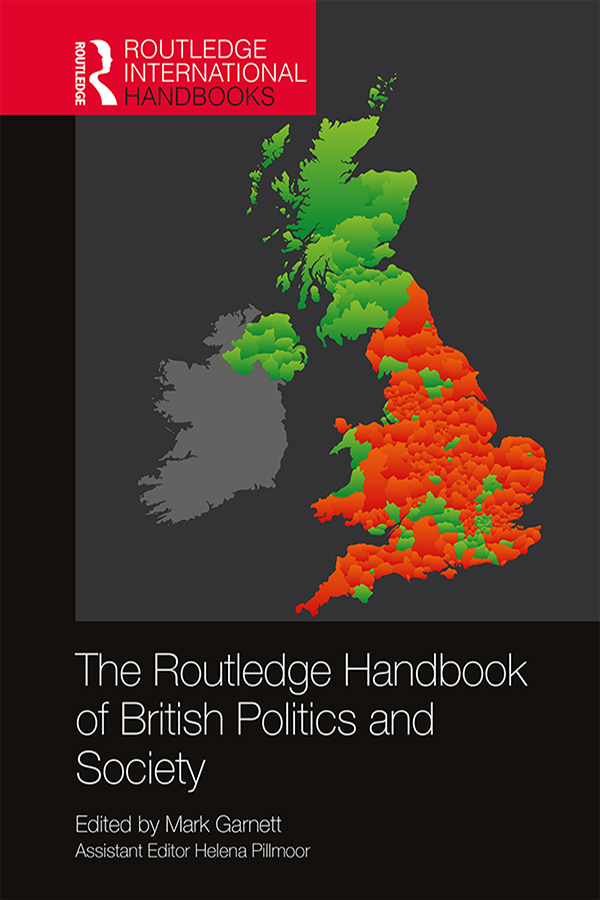
The Routledge Handbook of British Politics and Society The Routledge Handbook of British Politics and Society conducts a rigorous, innovative and distinctive analysis of the relationship between British politics and society, emphasizing that the UK is now far from a monolithic, and unshifting, entity. Examining the subject matter with unrivalled breadth and depth, it highlights and interrogates key contemporary debates on the future of the UK, the nature of 'Britishness', and the merits of multiculturalism, as well as contemporary criticisms of traditional institutions and the nature of representative democracy itself. Including contributions from key authors in their respective fields who bring their authority to bear on the task of outlining the current state of the art in British Studies, the book provides a fresh examination of the contrasts and the continuities across the whole field of British Politics and Society, while setting out agendas for future research. The Routledge Handbook of British Politics and Society will be essential reading and an authoritative reference for scholars, students, researchers and practitioners involved in, and actively concerned about, research on British politics, society and culture. POLITICAL SCIENCE,General
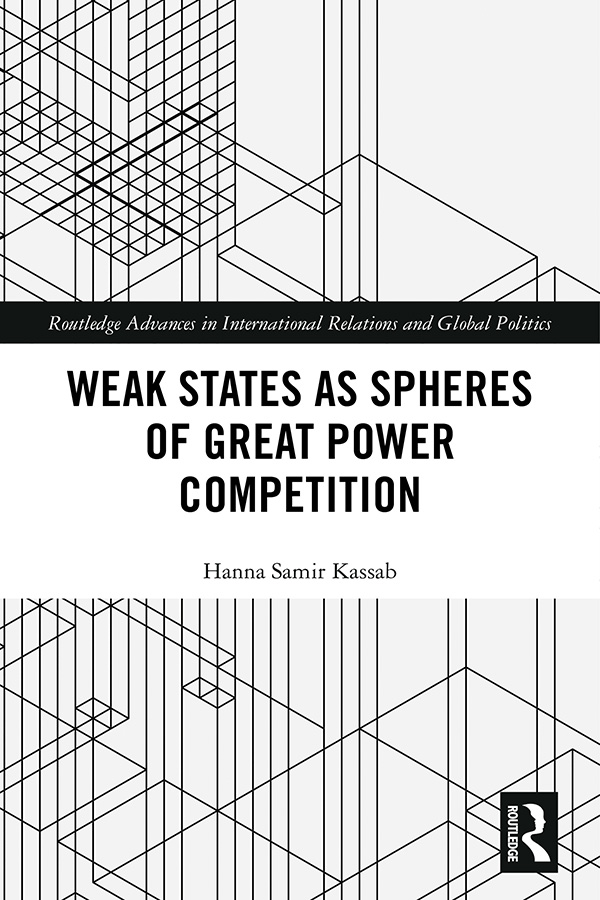
Weak States and Spheres of Great Power Competition This book explains the development of the international system’s present-day balance of power by exploring three central questions: (1) Under what conditions has the international system order evolved from a unipolar system to the current multipolar system? (2) What are its major states? (3) How do weak powers affect great power competition? It puts forward the following hypotheses: (1) if China and Russia are expanding their military, political, and economic influence into weaker states globally, then the unipolar American order is unraveling; and (2) if the international system is multipolar, then great power balancing may enhance international security. However, balancing may be made difficult because of weak state aid-seeking behavior. When weak states engage competing great powers, they become spheres of competition. This book delves into these states. Whether in Africa, Latin America, the Middle East, Central Asia, East Asia, or Eastern Europe, great powers hope to establish some control over weaker units for security, economic, and at times, prestige purposes. This book will be of interest to students and scholars of political science and IR, security studies, and IPE, as well as members of the think tank community and policy analysts. POLITICAL SCIENCE,General
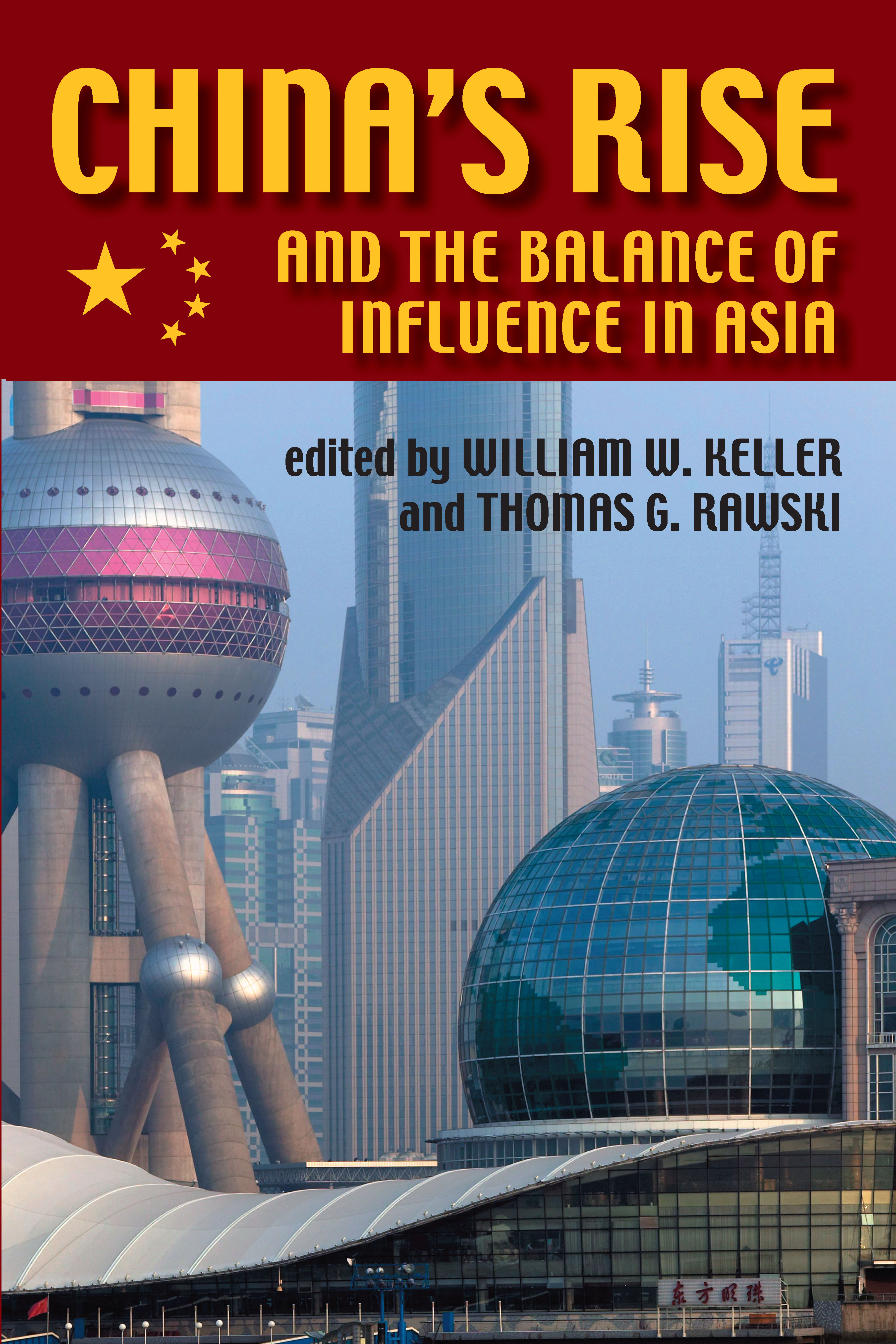
China's Rise and the Balance of Influence in Asia China's protracted boom and political transformation is a major episode in the history of global political economy. Beginning in the late 1970s, China experienced a quarter century of extraordinary growth that raised every indicator of material welfare, lifted several hundred million out of poverty, and rocketed China from near autarky to regional and even global prominence. These striking developments transformed China into a major U.S. trade and investment partner, a regional military power, and a major influence on national economies and cross-national interchange throughout the Pacific region. Beijing has emerged as a voice for East Asian economic interests and an arbiter in regional and even global diplomacy-from the Asian financial crisis to the North Korean nuclear talks. China's accession to the World Trade Organization promises to accentuate these trends. The contributors to this volume provide a multifaceted examination of China in the areas of economics, trade, investment, politics, diplomacy, technology, and security, affording a greater understanding of what relevant policies the United States must develop. This book offers a counterweight to overwrought concerns about the emerging “Chinese threat†and makes the case for viewing China as a force for stability in the twenty-first century. POLITICAL SCIENCE,General
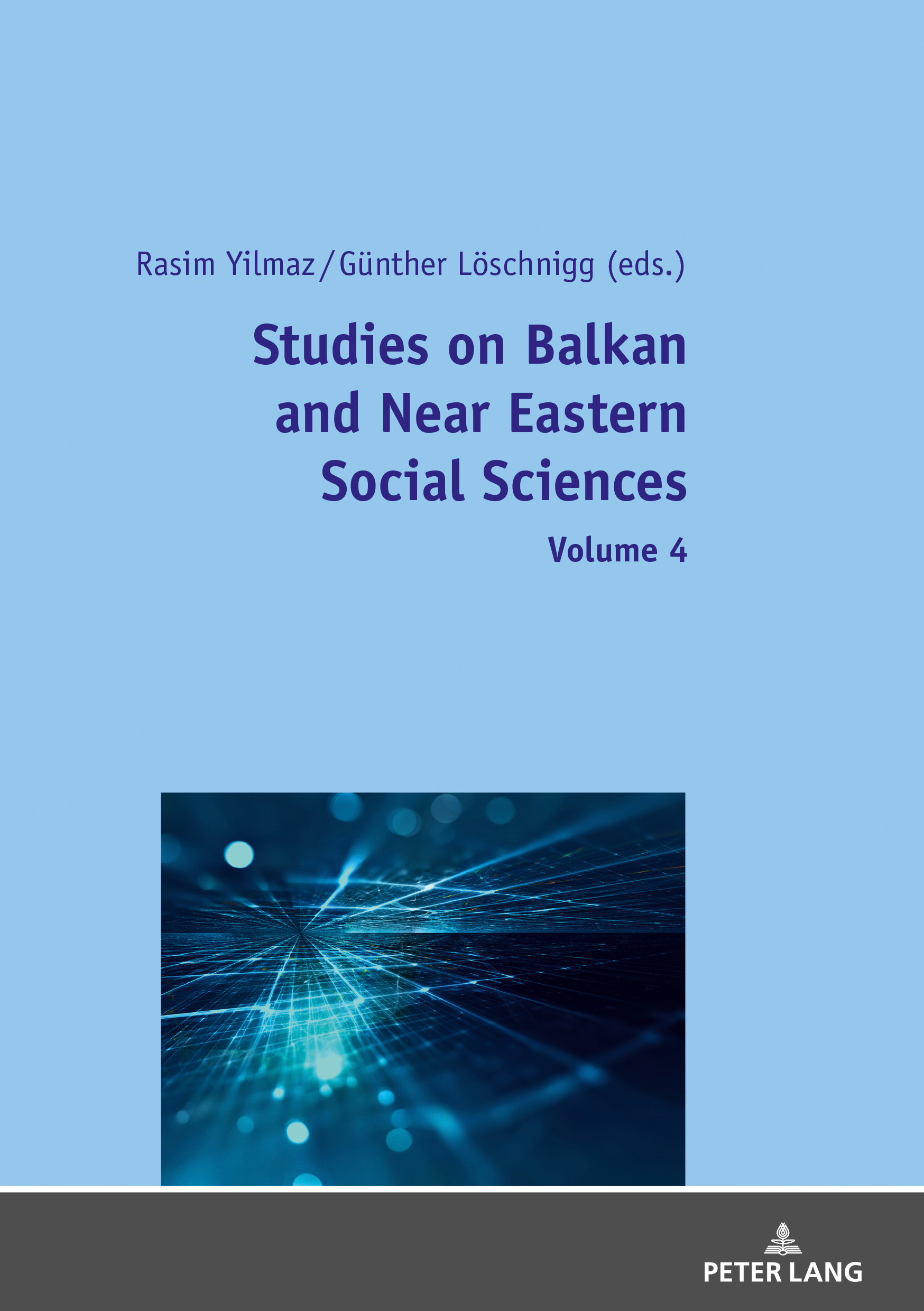
Studies on Balkan and Near Eastern Social Sciences This volume is a collection of empirical and theoretical research papers in the social sciences regarding the Balkans and the Near East. The book addresses economic, financial, political, historical, sociological, and international relations and health, cultural, and feminist issues in the region of the Balkan and the Near East. POLITICAL SCIENCE,General

Women's Political Communication in Africa This book examines women’s political communication in Africa, capturing previously unheard women’s voices, and presenting detailed information on overlooked communication strategies and forms of power relations employed by African women and women of African descent. By examining the disputes, accomplishments and/or setbacks experienced by women in political spaces, it underscores feminist intersections of political communication in Africa. It also explores the glamor, humor, harmony and tact that women as state and non-state actors have contributed to Africa’s political landscape through the realities of female soft power. The book addresses issues concerning how and why women do and should participate in politics; at what level they have employed political communication strategies; and which types. It also questions ideas and ideals that have guided or continue to guide feminist political communication in Africa’s growing democracy. Lastly, it highlights African women’s conscious approach and rejuvenated interest in developing their communication skills and strategies given their vital role in state-building. POLITICAL SCIENCE,General
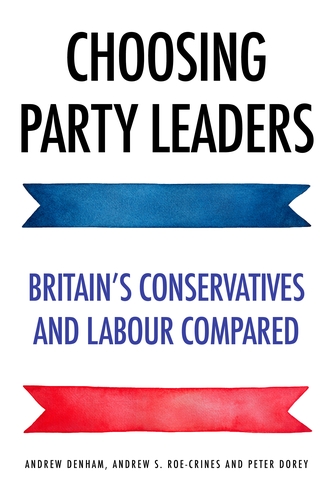
Choosing party leaders How political parties choose their leaders, and why they choose the leaders they do, are questions of fundamental importance in contemporary parliamentary democracies. This book examines political leadership selection in the two dominant parties in recent British political history, exploring the criteria and skills needed by political leaders to be chosen by their parties.While the Conservative Party’s strong record in office owes much to its ability to project an image of leadership competence and governing credibility, the Labour Party has struggled with issues of economic management, leadership ability and ideological splits between various interpretations of socialism. The authors argue that the Conservatives tend towards a unifying figure who can lead the Party to victory, whereas the Labour Party typically choose a leader to unite the party behind ideological renewal.Exploring the contemporary political choices of leaders like Boris Johnson and Jeremy Corbyn, this book offers a timely insight into the leadership processes of Britain’s major political players. POLITICAL SCIENCE,General
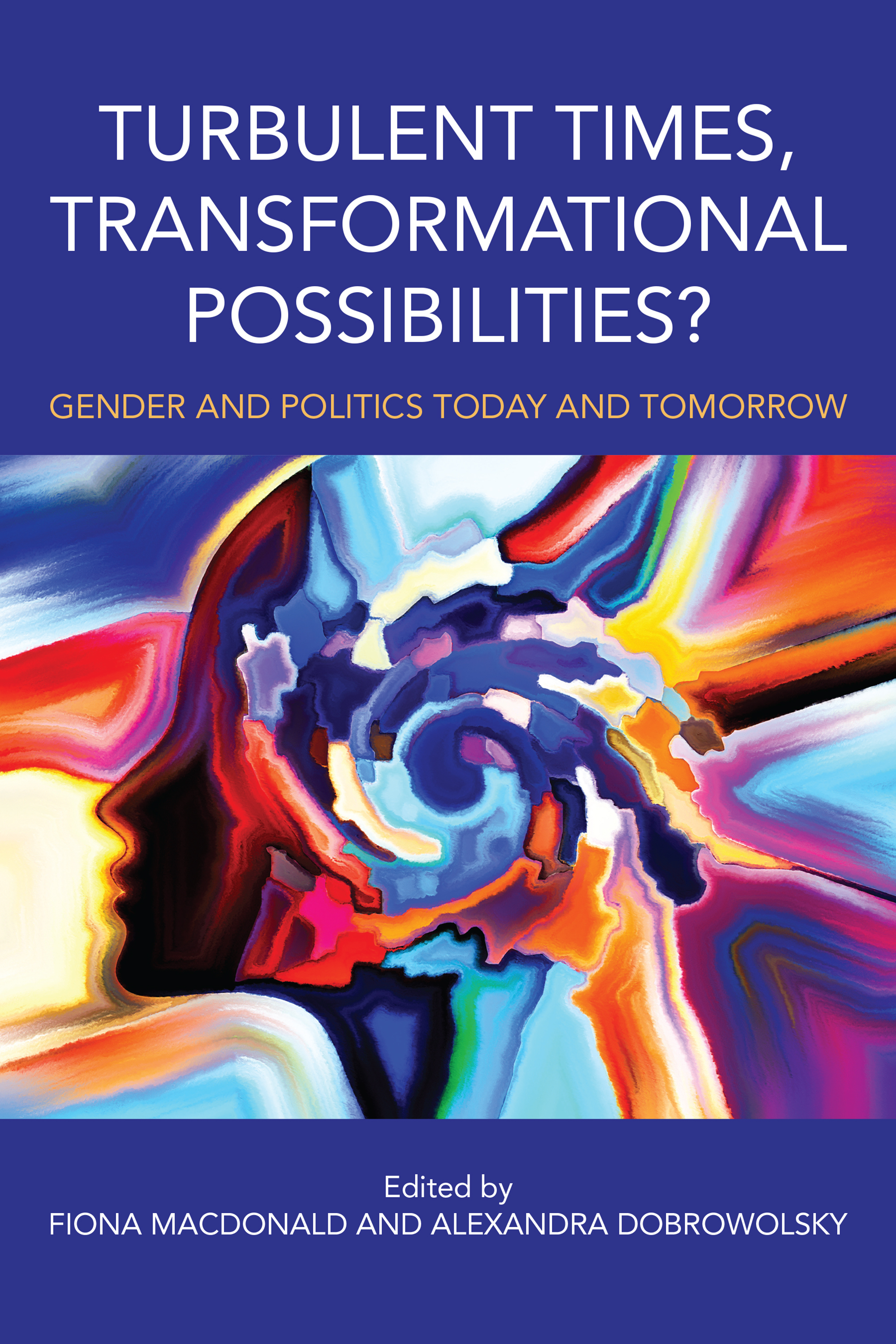
Turbulent Times, Transformational Possibilities? This edited collection features state-of-the art scholarship by diverse contributors on a contemporary array of compelling and contentious gender and politics concerns. POLITICAL SCIENCE,General
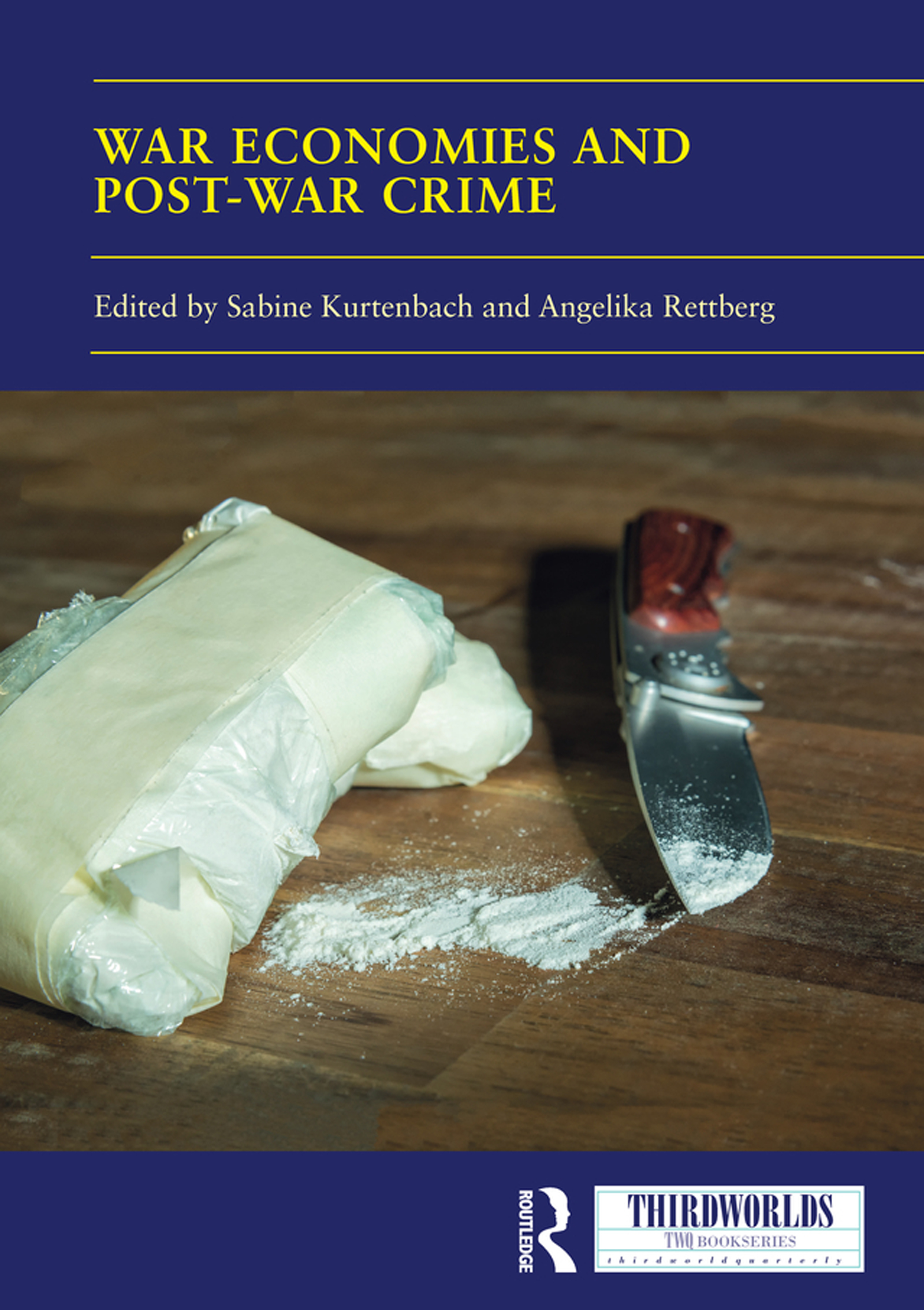
War Economies and Post-war Crime Even when armed conflicts formally end, the transition to peace is not clear-cut. This comprehensive volume explores the mounting evidence which suggests that it is rather ‘unlikely to see a clean break from violence to consent, from theft to production, from repression to democracy, or from impunity to accountability’. The authors analyse the complex endeavour of transitioning out of war, studying how it is often interrelated with other transformations such as changes in the political regime (democratisation) and in the economy (opening of markets to globalisation). They explore how, in the same way as wars and conflicts reflect the societies they befall, post-war orders may replicate and perpetuate some of the drivers of war-related violence, such as high levels of instability, institutional fragility, corruption, and inequality. This book thus suggests that, even in the absence of a formal relapse into war and the re-mobilisation of former insurgents, many transitional contexts are marked by the steady and ongoing reconfiguration of criminal and illegal groups and practices. This book will be of great interest to students and researchers of political science and peace studies. It was originally published as an online special issue of Third World Thematics. POLITICAL SCIENCE,General

International-Led Statebuilding and Local Resistance International-Led Statebuilding and Local Resistance contributes theoretical and empirical insights to the existing knowledge on the scope, challenges and results of post-conflict international state- and institution-building project focusing on post-war Kosovo. Post-war Kosovo is one of the high-profile cases of international intervention, hosting a series of international missions besides a massive inflow of international aid, technical assistance and foreign experts. Theoretically, the book goes beyond the standard narrative of international top-down institution building by exploring how international and local factors interact, bringing in the mediating role of local resistance and highlighting the hybridity of institutional change. Empirically, the book tests those alternative explanations in key areas of institutional reform – municipal governance, public administration, normalization of relations with Serbia, high education, creation of armed forces, the security sector and the hold of Salafi ideologies. The findings speak to timely and pertinent issues regarding the limits of international promotion of effective institutions; the mediating role of local agents; and the hybrid forms of institution-building taking shape in post-conflict Kosovo and similar post-war contexts more broadly. Addressing challenges of state-building at the intersection of international interventions, local strategies of resistance, and the hybridity of institution-building experience with institutional reforms in Kosovo and in post-conflict contexts more broadly, International-Led Statebuilding and Local Resistance will be of great interest to scholars of international relations, state building and post-conflict societies. The chapters were originally published as a special issue of Southeast European and Black Sea Studies. POLITICAL SCIENCE,General

Reconfigurations of Political Space in the Caucasus In order to analyse configurations of power that transcend the territorial trap, the Caucasus is an excellent case in point. Its past and present exhibit an extraordinary richness in power practices of diverse forms that intersect on various scales. This comprehensive volume offers an innovative procedural perspective on the actual workings of power not necessarily tied to the nation-state. Its focus goes well beyond national scales to tackle the manifold impacts of transboundary flows. The authors, from a wide range of academic disciplines, provide original empirical data from this intriguing but largely untapped region, with respect to the critical study of statehood. They also shed light on the diversity of political space and the ongoing process of spatial re-alignment. The chapters in this collection focus on: land governance practice in the North Caucasus; practices of local administration in Georgia; Shia influence from Iran in Azerbaijan; and trajectories of Ottoman influence in Adjara and Abkhazia respectively. They cover the South as well as North Caucasus, examining configurations of power that entangle smaller and larger scales, and providing perspectives on transboundary flows between the area and both Turkey and Iran. This book was originally published as a special issue of the journal Eurasian Geography and Economics. POLITICAL SCIENCE,General
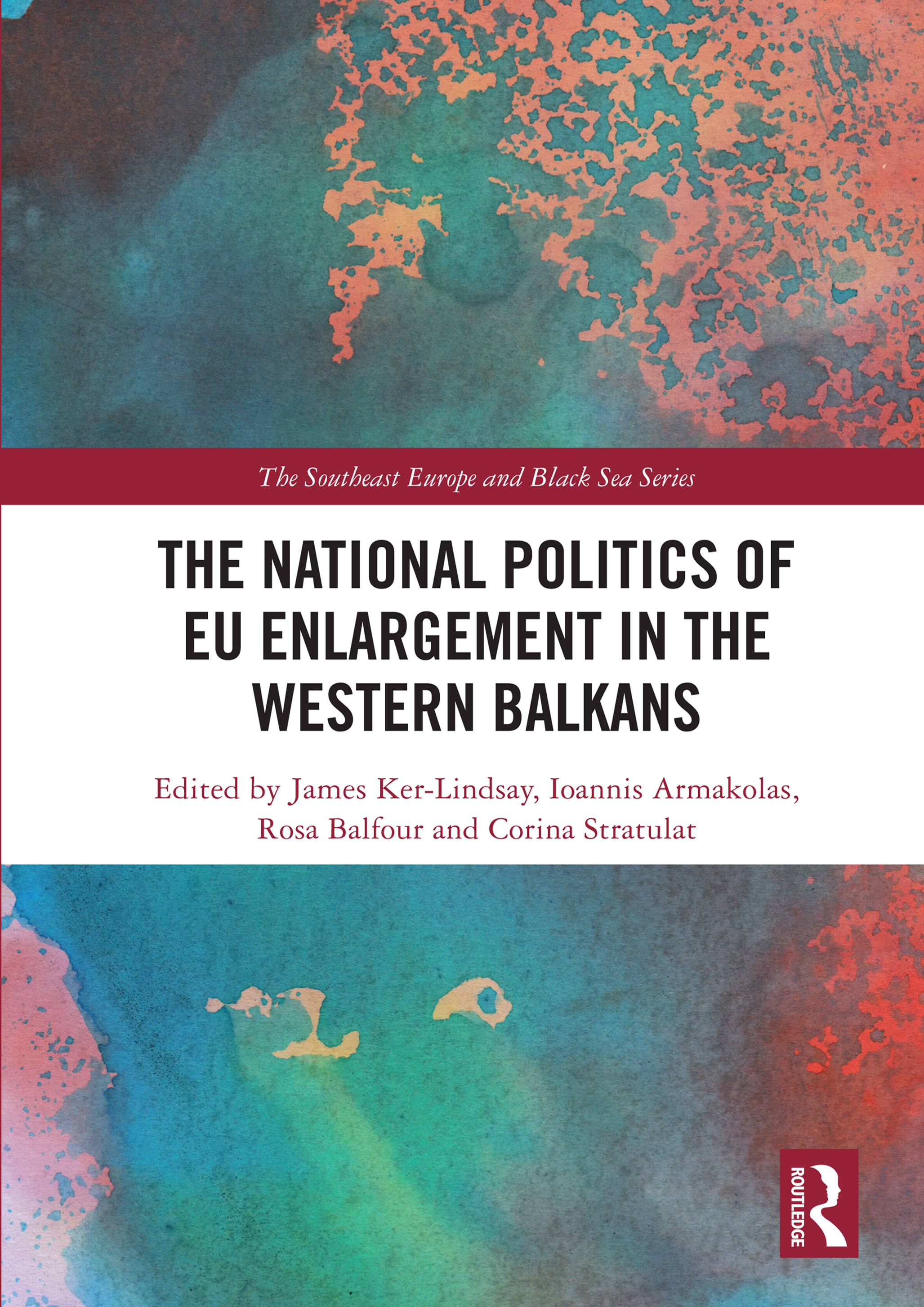
The National Politics of EU Enlargement in the Western Balkans The National Politics of EU Enlargement in the Western Balkans examines the way in which a number of European Union member states, including Germany and France, formulate their policies towards enlargement in the Western Balkans. The six countries of the Western Balkans – Albania, Bosnia and Herzegovina, Kosovo, Montenegro, North Macedonia and Serbia – are on course to become the next members of the European Union. While there has been a lot of work on the ways in which these countries are preparing for accession, and how the EU as a whole approaches the question of expansion, very little attention has been paid to how individual EU member states regard enlargement into a region that presents a number of serious challenges, including the legacies of the conflicts of the 1990s, economic underdevelopment and poor governance. Focusing on key states, such as Germany, France and Italy, the neighbouring countries of Central and South East Europe, and Britain, once a leading advocate of enlargement that is now in the process of leaving the European Union, this volume casts important new empirical and conceptual light on the diverse motivations that underpin member state attitudes towards EU enlargement. The National Politics of EU Enlargement in the Western Balkans will be of great interest to scholars of the European Union, European politics, and the politics of the Western Balkans. The chapters were originally published as a special issue of Southeast European and Black Sea Studies. POLITICAL SCIENCE,General

Russia as Civilization Analyzing the use of civilization in Russian-language political and media discourses, intellectual and academic production, and artistic practices, this book discusses the rise of civilizational rhetoric in Russia and global politics. Why does the concept of civilization play such a prevalent role in current Russian geopolitical and creative imaginations? The contributors answer this question by exploring the extent to which discourse on civilization penetrates Russian identity formations in imperial and national configurations, and at state and civil levels of society. Although the chapters offer different interpretations and approaches, the book shows that Russian civilizationism is a form of ideological production responding to the challenges of globalization. The concept of "civilization," while increasingly popular as a conceptual tool in identity formation, is also widely contested in Russia today. This examination of contemporary Russian identities and self-understanding will be of particular interest to students and scholars of Russian area studies and Slavic studies, intellectual and cultural history, nationalism and imperial histories, international relations, discourse analysis, cultural studies, media studies, religion studies, and gender studies. POLITICAL SCIENCE,General

Compromising on Justice When we compromise on justice, we accept or acquiesce to an arrangement that we judge to be unjust, or at least not fully just. Such arrangements are often described as constituting a ‘modus vivendi’. What reasons could we have to accept a modus vivendi, thereby compromising on justice? Given the fact of disagreement on justice, this is an important, but rather neglected question in political philosophy. One possible answer, inspired by John Rawls, is that compromising on justice is only justified if this nonetheless brings us as close to ideal justice as possible under given circumstances. The most straightforward way to take issue with this answer is to present other reasons to compromise on justice. The articles in this book explore epistemic reasons and those that stem from values besides justice, like democracy, peace, toleration and non-subjugation. This book thereby sheds some light on the relevance of compromising for the legitimacy of institutional arrangements. This book was previously published as a special issue of the Critical Review of Social and Political Philosophy. POLITICAL SCIENCE,General
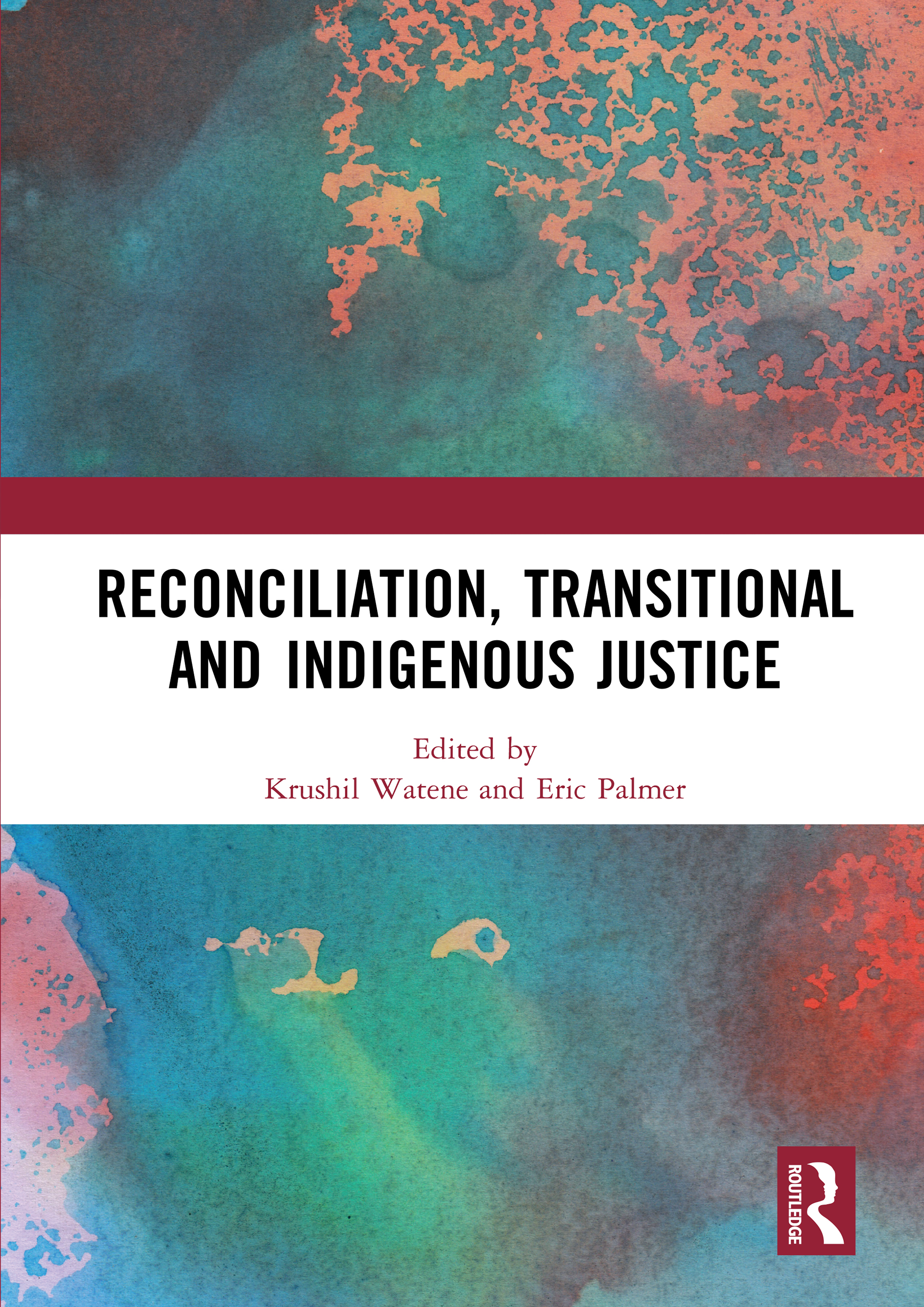
Reconciliation, Transitional and Indigenous Justice Reconciliation, Transitional and Indigenous Justice presents fifteen reflections upon justice twenty years after the Truth and Reconciliation Commission of South Africa introduced a new paradigm for political reconciliation in settler and post-colonial societies. The volume considers processes of political reconciliation, appraising the results of South Africa's Commission, of the recently concluded Truth and Reconciliation Commission of Canada and of the on-going process of the Waitangi Tribunal of Aotearoa New Zealand. Contributors discuss the separate politics of Indigenous resurgence, linguistic justice, environmental justice and law. Further contributors present a theoretical symposium focused on The Conceptual Foundations of Transitional Justice, authored by Colleen Murphy, who provides a response to their comments. Indigenous and non-Indigenous voices from four regions of the world are represented in this critical assessment of the prospects for political reconciliation, for transitional justice and for alternative, nascent conceptions of just politics. Radically challenging assumptions concerning sovereignty and just process in the current context of settler-colonial states, Reconciliation, Transitional and Indigenous Justice will be of great interest to scholars of Ethics, Indigenous Studies, Transitional Justice and International Relations more broadly. With the addition of one chapter from The Round Table, the chapters in this book were originally published as a special issue in the Journal of Global Ethics. POLITICAL SCIENCE,General
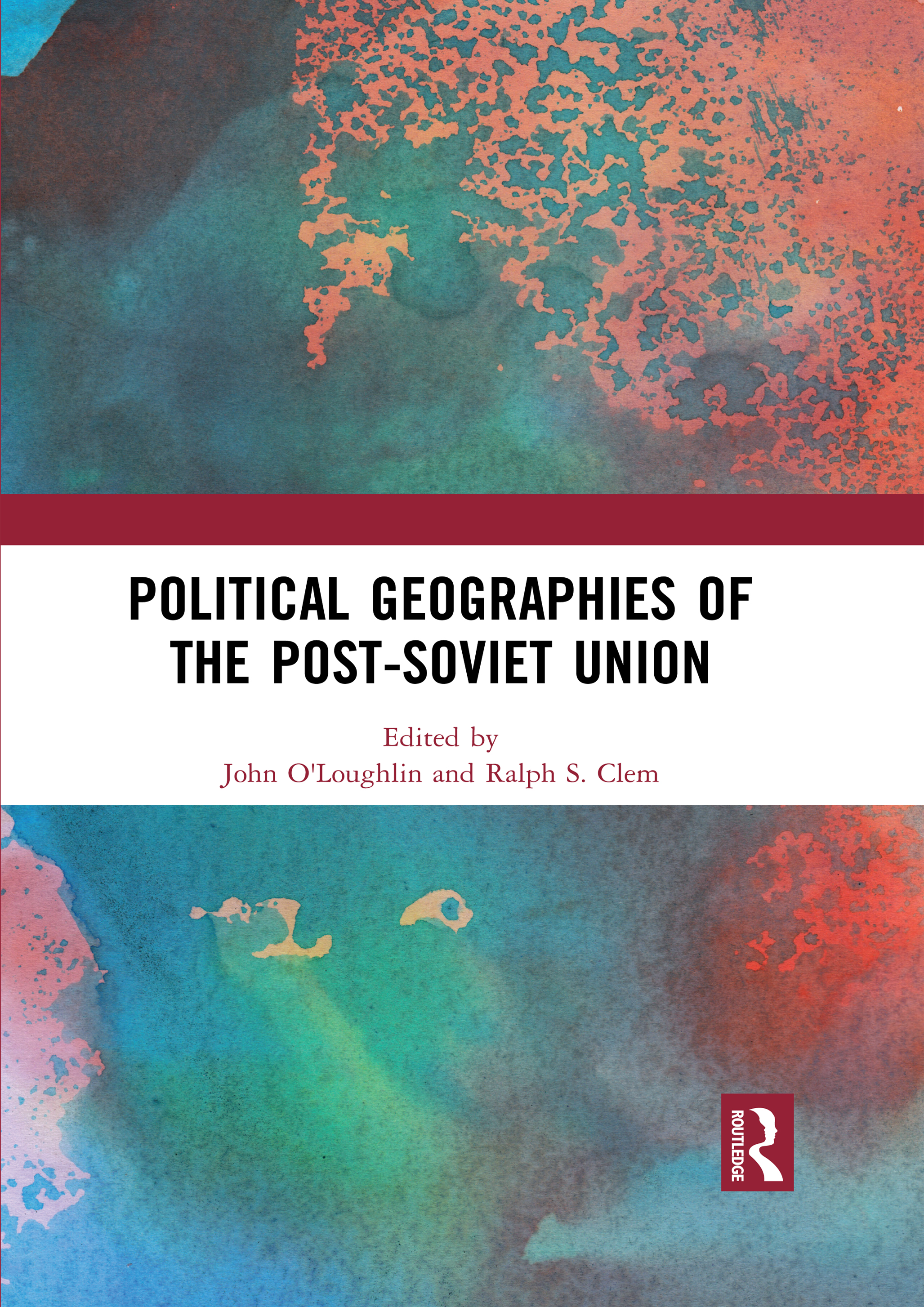
Political Geographies of the Post-Soviet Union This comprehensive volume observes how, after 25 years of transition and uncertainty in the countries that constituted the former Soviet Union, their political geographies remain in a state of flux. The authors explore the fluid relationship between Russia, by far the dominant economic and military power in the region, and the other former republics. They also examine new developments towards economic blocs, such as membership in the European Union or the competing Eurasian Economic Union, as well as new security arrangements in the form of military cooperation and alliance structures. This book reflects the broad range of changes across this important world region by engaging in insightful analysis of current developments in Central Asia, Ukraine, Russia, the Caucasus, and separatist regions. The authors explore new state alliances and the evolving cultural and geopolitical orientations of former Soviet citizens. Some chapters also examine the dynamics of wars that have occurred in the post-Soviet space, as well as how local political developments are reflected in electoral preferences and struggles over control of public spaces. The chapters in this book were originally published in the journal Eurasian Geography and Economics. POLITICAL SCIENCE,General

Studying the State Studying the State explores the results of governments in the Global South, particularly in Latin America, turning to the state as a vehicle for mobilizing people, resources and political change. The book evaluates the results of this return to the state by looking at recent historical events to analyse the outcomes, processes, successes and failures of these projects. It also explores the role of China in affecting the margins of manoeuvrability of states, especially Latin American states. Finally, the book considers various perspectives on the theory of the state, contributing to theoretical approaches in the social sciences but in a way that is always grounded in their utility for addressing real-world problems. Contributing to theoretical understandings of the state through grounded case studies, Studying the State will be of great interest to scholars of Latin America, the Global South and neoliberalism and the state. This book was originally published as a special issue in Third World Thematics. POLITICAL SCIENCE,General
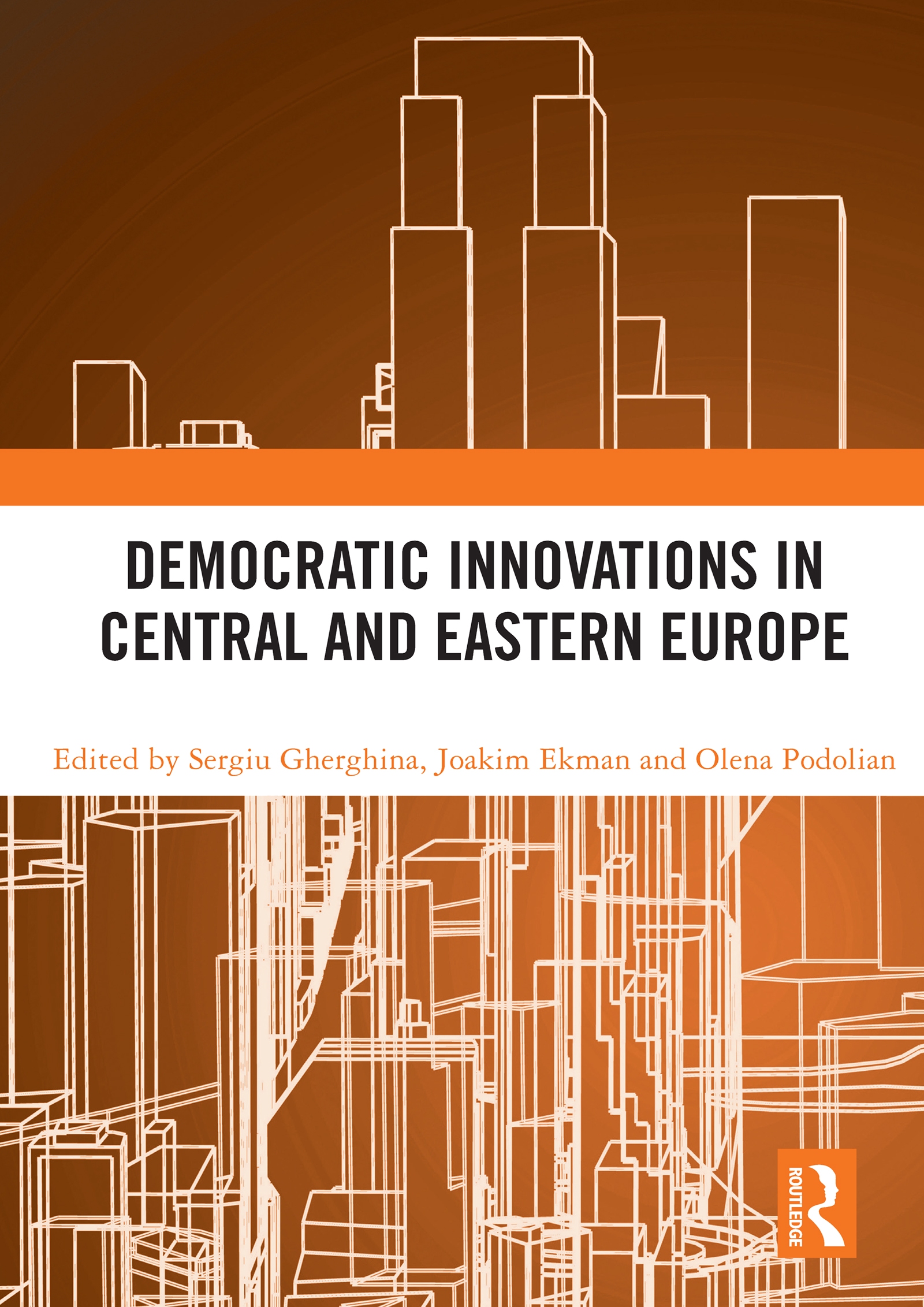
Democratic Innovations in Central and Eastern Europe Democratic Innovations in Central and Eastern Europe expands research on democratic innovations by looking specifically at different forms of democratic innovations in Central and Eastern Europe. The book covers direct democracy (referendums in particular), deliberative democracy practices and e-participation – forms which are salient in practice because they match the political realities of our time. Expert contributors show how the recent actions of ordinary citizens in several Central and Eastern European countries have challenged the contemporary political order, and grassroots movements and diverse forms of mobilization have challenged the notion of weak civil societies in the East. The empirical evidence presented attempts to deepen citizen involvement in political contexts sometimes quite different from the democratic political systems in the Western world. Using lessons from a still largely underexplored part of Europe, the book both complements and revises theoretical approaches, or complements empirical results in existing studies on democratic innovations. Democratic Innovations in Central and Eastern Europe will be of great interest to scholars working on democracy, political systems, political engagement, and Central and Eastern European politics. The chapters originally published as a special issue of Contemporary Politics. POLITICAL SCIENCE,General

Assessing Political Representation in Europe It has long been realized that democratic governance requires a two-way flow of influence. Governments must be able to respond to what people want and people must be able to react to what governments do. These mechanisms of democratic governance have contributed to two research traditions: one, the responsible party approach, views policy change as a consequence of ‘electoral turnover’; and the other, the dynamic representation approach, views policy change as occurring in ‘rational anticipation’ of electoral repercussions. The aim of this book is to evaluate the state of political representation in contemporary Europe in the light of these two approaches. The chapters present fresh insight into issue congruence between voters and parties and into the extent of dynamic representation. The chapters are logically clustered into three groups: one group of scholars base their work on the ‘responsible party model’ and apply it to voters and European parties and party groups; a second group of scholars demonstrate the importance of institutional structures on the degree of issue congruence; and a third group of scholars examine the reciprocal nature of dynamic representation and the effects of institutions on the opinion-policy connection. This book was published as a special issue of West European Politics. POLITICAL SCIENCE,General
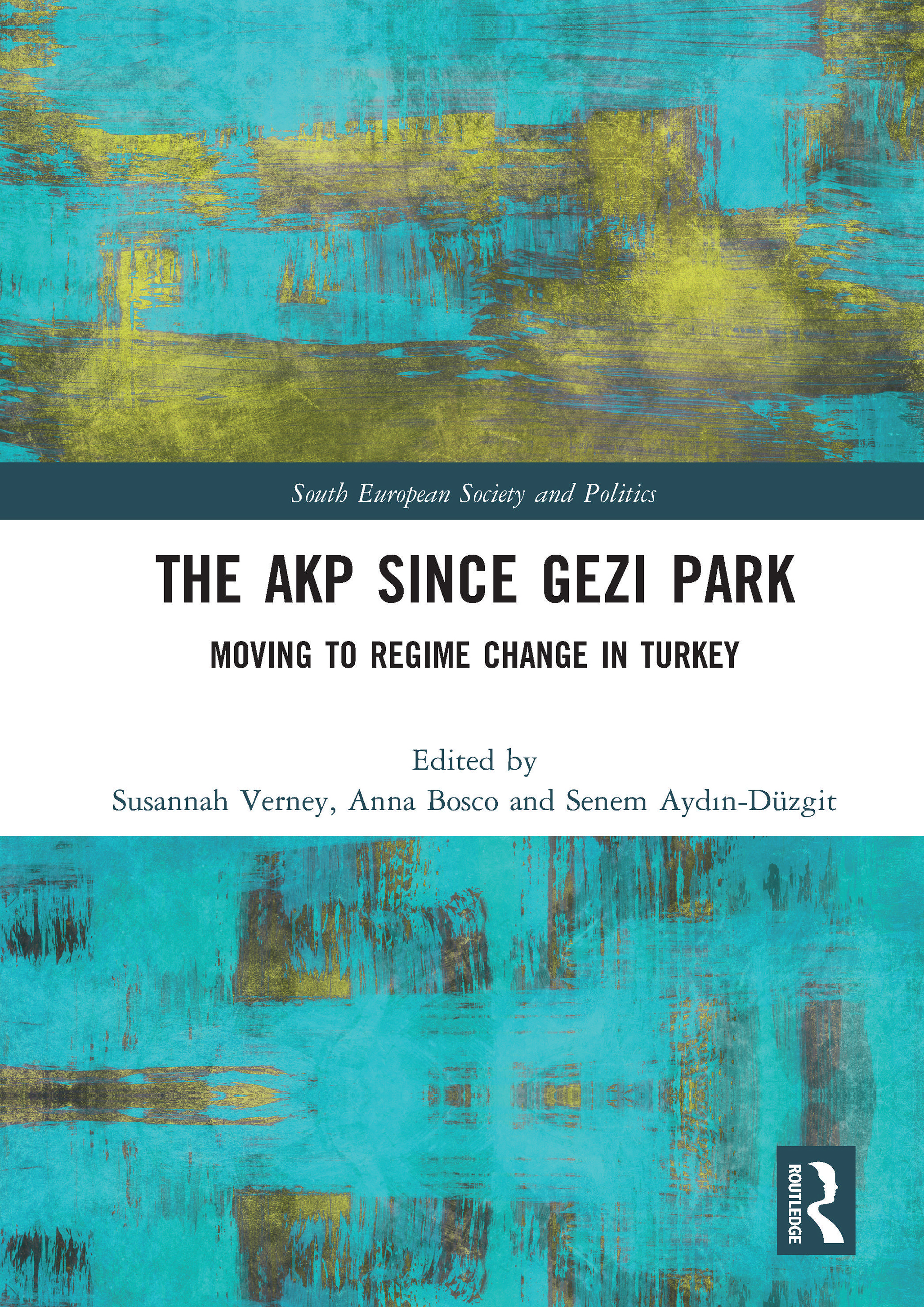
The AKP Since Gezi Park While the Justice and Development Party (AKP) has dominated Turkish politics for a decade and a half, recent years have seen a qualitative change, culminating in the 2017 referendum on the move to a presidential system. This volume focuses on the later years of AKP rule after the first direct presidential election in 2014. It shows how during this period the AKP has changed the political system and societal dynamics, maintained its electoral predominance, and ultimately opened the way for regime change. This collection of key chapters offers indispensable reading for everyone who wants to understand current Turkish politics and the continued hegemony of the AKP in the country’s political life. Chapters 2–10 previously published as articles (Vol 19: issue 2 to Vol 22: issue 3) in South European Society and Politics. POLITICAL SCIENCE,General

Russia and the Question of World Order Russia and the Question of World Order engages with three sets of questions that cut to the heart of the ongoing debate about Russia’s role in the present world order. Firstly, the book asks what are Russia’s aims and objectives? Is Russia a highly revisionist power bent on overturning established rules and institutions, or is it best understood as a country with limited ambitions? Secondly, contributors ask what factors shape Russia’s views on the global order and its foreign policy choices? And finally, they ask what are the consequences of Russia’s actions for the existing international order? To answer these questions the book brings together scholars who analyse Russia’s world order policies through the lenses of different theoretical approaches, including the English School, E.H. Carr’s classical realism, social constructivism, and a long durée perspective. Examining Russia’s role in the present world order, with a special focus on Moscow’s relations with the US, China, and the EU, Russia and the Question of World Order will be of great interest to scholars of international relations and Russian foreign policy. The chapters were originally published as a special issue of European Politics and Society. POLITICAL SCIENCE,General
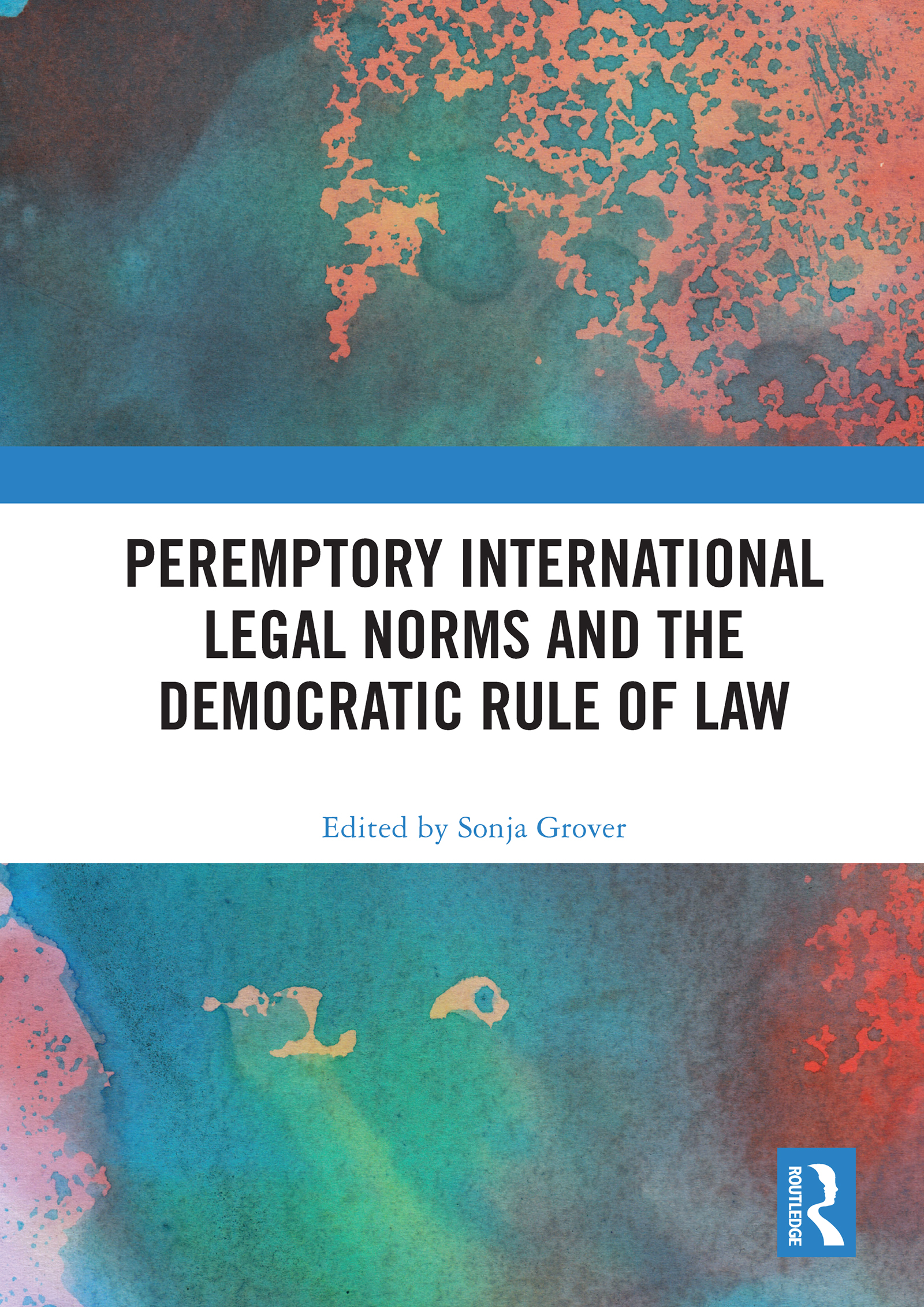
Peremptory International Legal Norms and the Democratic Rule of Law Peremptory International Legal Norms and the Democratic Rule of Law explores the risks to the democratic State inherent in the attempt to divorce the notion of democratic rule of law from respect for and adherence to peremptory international legal norms which allow for no derogation therefrom such as the prohibition of torture and inhumane treatment or punishment by the State. The chapters address, with specific current case examples, in what ways the democratic rule of law within certain democratic States risks being undermined through those States acquiescing to the erosion of peremptory international law norms in the domestic and international context. The book therefore explores the question of in what ways such democratic State acquiescence in effect may ultimately disrupt the investment within the State in the shared culture of core human rights values that underlies democratic rule of law itself and highlights the fragility of that shared culture. The contributors argue for a renewed commitment in principle and practice to the democratic rule of law and to its human rights international normative underpinnings. Peremptory International Legal Norms and the Democratic Rule of Law will be of great interest to scholars of international law, human rights and democracy. The chapters originally published as a special issue of The International Journal of Human Rights. POLITICAL SCIENCE,General
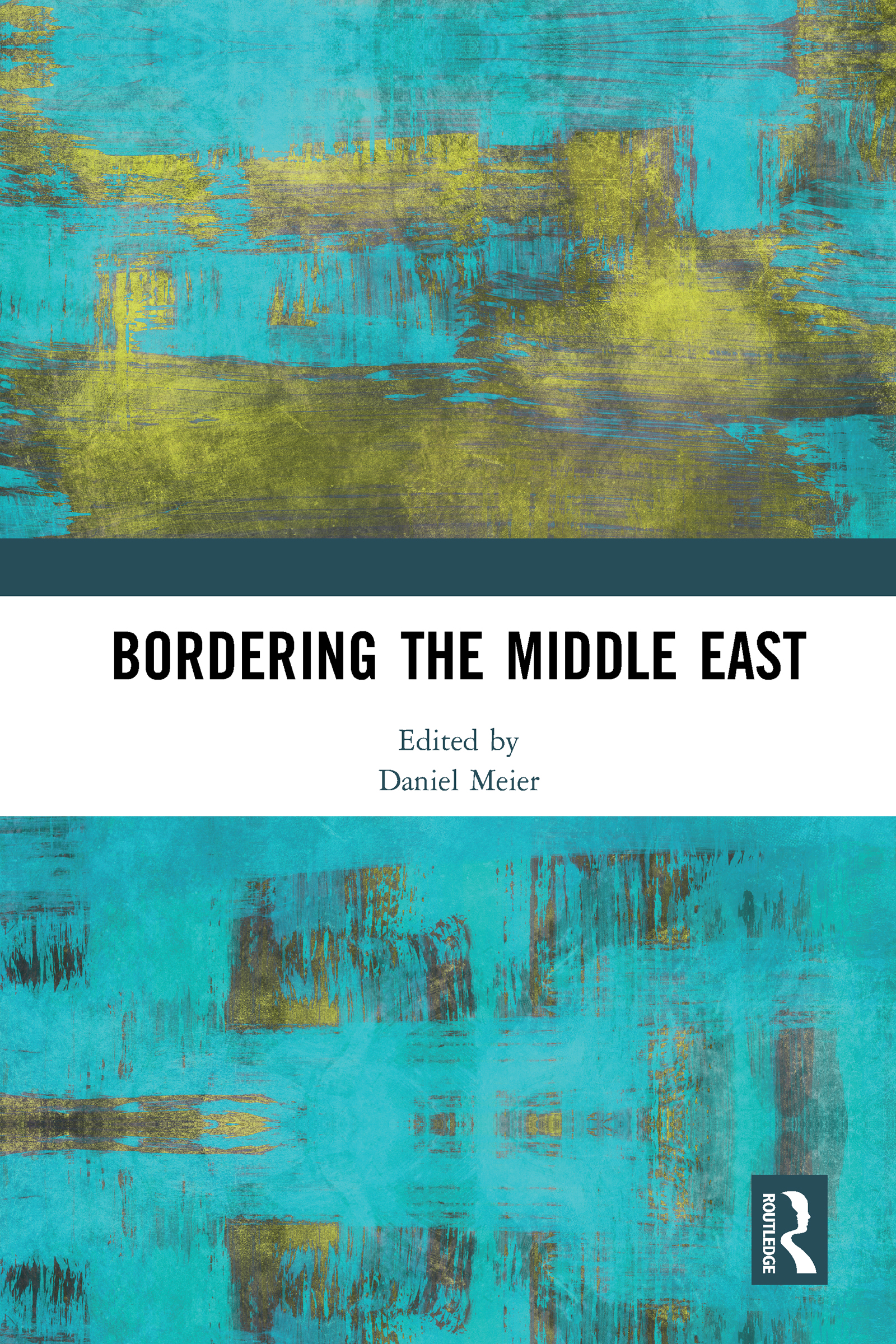
Bordering the Middle East This volume focuses on the influence that borders in the Middle East can have on actors’ identity building, as well as how local, national, or transnational actors re/ define borders and boundaries. The Middle East is facing a political crisis, revealed by the Arab uprisings, that is affecting states’ borders in a paradoxical way: while local, communal, or tribal dissent tends to contest international borders, states are trying to affirm their control over national territory in building border fences. Focusing on borders in their materiality as well as their symbolic dimensions – their representations – may help with reappraising the region’s own history, the local/national specificities, as well as regional/ global constraints affecting borderlands and those who cross borders; be they workers, migrants, or jihadists. In this book, six case studies will provide insights on state- community relationships through the lens of border issues in the Levant and the Gulf. The theoretical framework provided by the border studies conceptual tools allows authors to delve into the process of bordering, de- bordering, and re- bordering which is affecting the region, raising questions on sovereignty, authority, and the political legitimacy of the regimes. This book was originally published as a special issue of Geopolitics. POLITICAL SCIENCE,General

Ontological Insecurity in the European Union The European Union (EU) faces many crises and risks to its security and existence. While few of them threaten the lives of EU citizens, they all create a sense of anxiety and insecurity about the future for many ordinary Europeans. This comprehensive volume explores the concept of ‘ontological security’ which was introduced into international relations over a decade ago to better understand the ‘security of being’ found in feelings of fear, anxiety, crisis, and threat to wellbeing. The authors make use of this concept to explore how narratives of European integration have been part of public discourses in the post-war period and how reconciliation dynamics, national biographical narratives and memory politics have been enacted to create ontological security. Within this context, they also discuss the anxiety of the ‘remainers’ in the Brexit referendum and the consequences of its failure to address the ontological anxieties and insecurities of remain voters. The book also explores: how European security firms market ontological security and provide an ontological security-inspired reading of the EU’s relations with post-communist states; the EU and NATO’s engagement with hybrid threats; and the EU as an anxious community. This book was originally published as a special issue of the journal European Security. POLITICAL SCIENCE,General
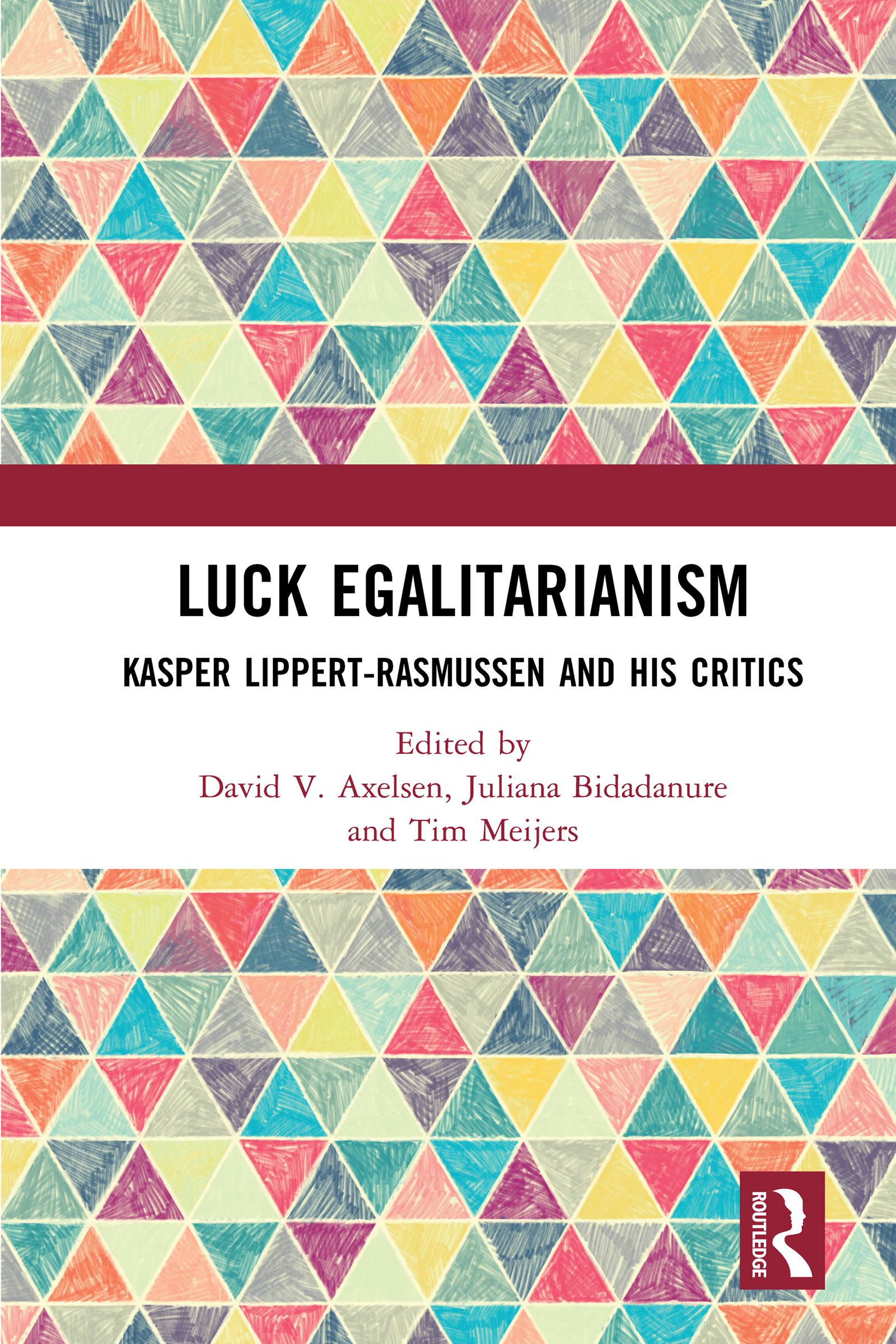
Luck Egalitarianism This edited volume offers a critical discussion of luck egalitarianism – one of the most prominent views in contemporary political philosophy – through an exploration of the theory of one of its leading proponents, Kasper Lippert-Rasmussen. When (if ever) can inequalities in how well peoples’ lives go be justified? Luck egalitarianism provides an appealing answer: inequalities are just if, and only if, they are the result of the exercise of individual responsibility. Kasper Lippert-Rasmussen lucidly defends and specifies this view in his own book Luck Egalitarianism. The authors in this volume offer a critical discussion of the key features of his view. They discuss disagreements within views which assign an important role to responsibility. They go on to push the limits of luck egalitarianism: what about inequalities between us and the dead? And inequalities between groups? Finally, they criticize some of the central tenets of luck egalitarianism, including its tendency to avoid action-guiding judgements and its focus on distributions rather than interpersonal relations. This book was originally published as a special issue of Critical Review of International Social and Political Philosophy. POLITICAL SCIENCE,General

The Political Economy of Pension Financialisation The Political Economy of Pension Financialisation addresses – for numerous countries – how and why pension reforms have come to rely more on financial markets, how public policy reacted to financial crises, and regulatory variation. The book demonstrates how the process of pension financialisation reveals that pension policy is not only a social policy that affects retirement income, but also a financial policy that impacts savings rates, corporate finance and the economy. The chapters shed light on pre-funded private pensions as one key component of financialisation, as they turn savings into investments via financial services providers. Readers will also see how pension financialisation and the broader financialisation of the economy are here to stay, despite negative developments during and after the financial crisis. A systematic and comparative overwiew of the financialisation of pensions, The Political Economy of Pension Financialisation is ideal for scholars and postgradues working on Political Economy, Public Policy and Finance. This book was originally published as a special issue of the Journal of European Public Policy. POLITICAL SCIENCE,General
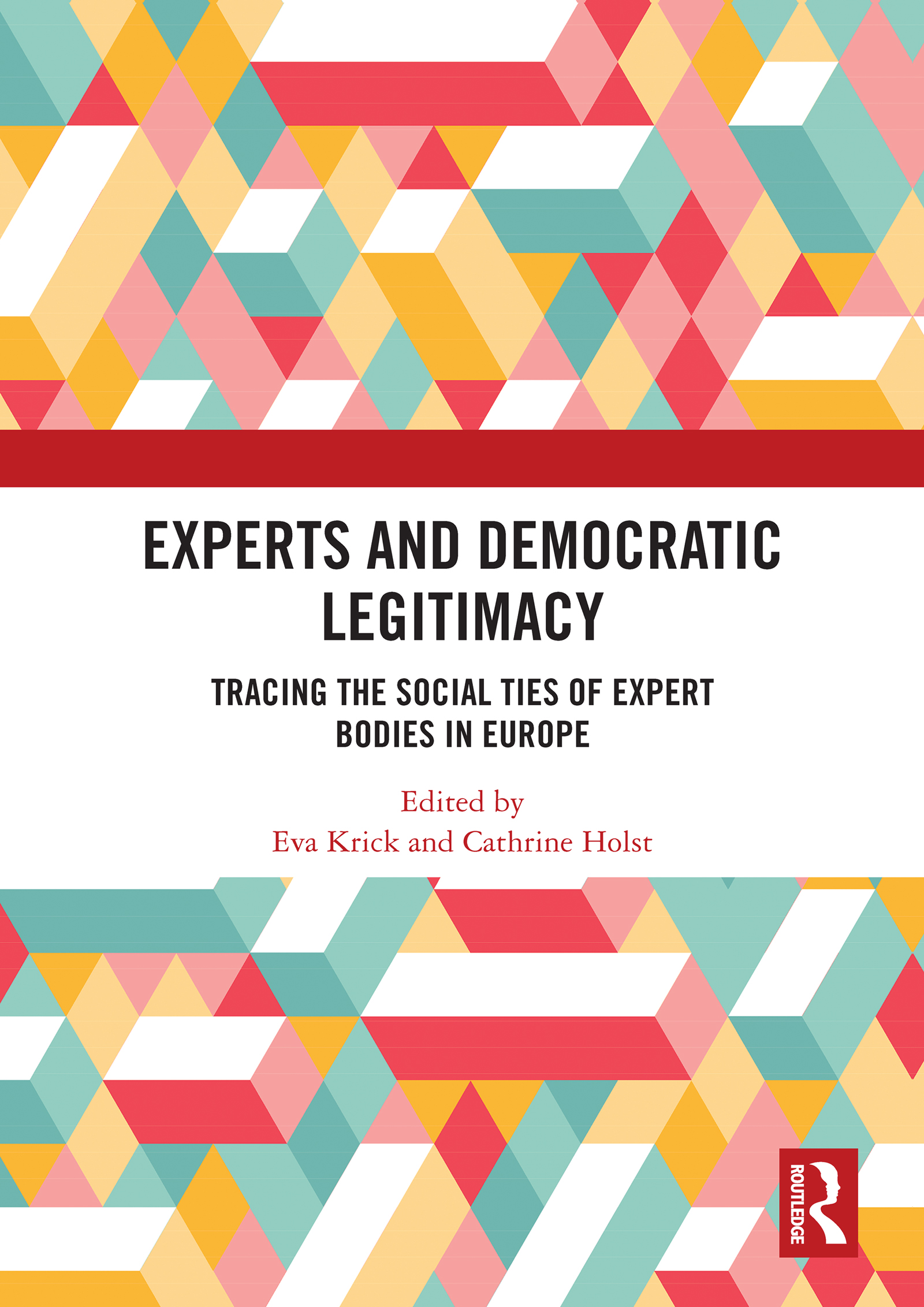
Experts and Democratic Legitimacy Experts and Democratic Legitimacy challenges the technocratic reading of expert bodies, such as central banks, advisory committees and regulatory agencies. Expert contributors ask in what way expert bodies are subject to some of the key pressures in contemporary governance, such as democratisation, politicisation and expertisation. Based on empirical studies, the book traces the multiple social ties of expert bodies and refines the common perception of expert bodies as ‘de-politicised’ institutions that are detached from political interference and societal input. It further theorises the tension and reconcilability between reliable, independent expert knowledge on the one hand and the need for accountability and legitimacy in modern policy-making on the other hand. Refining the detached, de-politicised image of non-majoritarian institutions, Experts and Democratic Legitimacy will be of great interest to scholars of European studies, political and social theory, modern governance and policy-making. This book was originally published as a special issue of European Politics and Society. POLITICAL SCIENCE,General
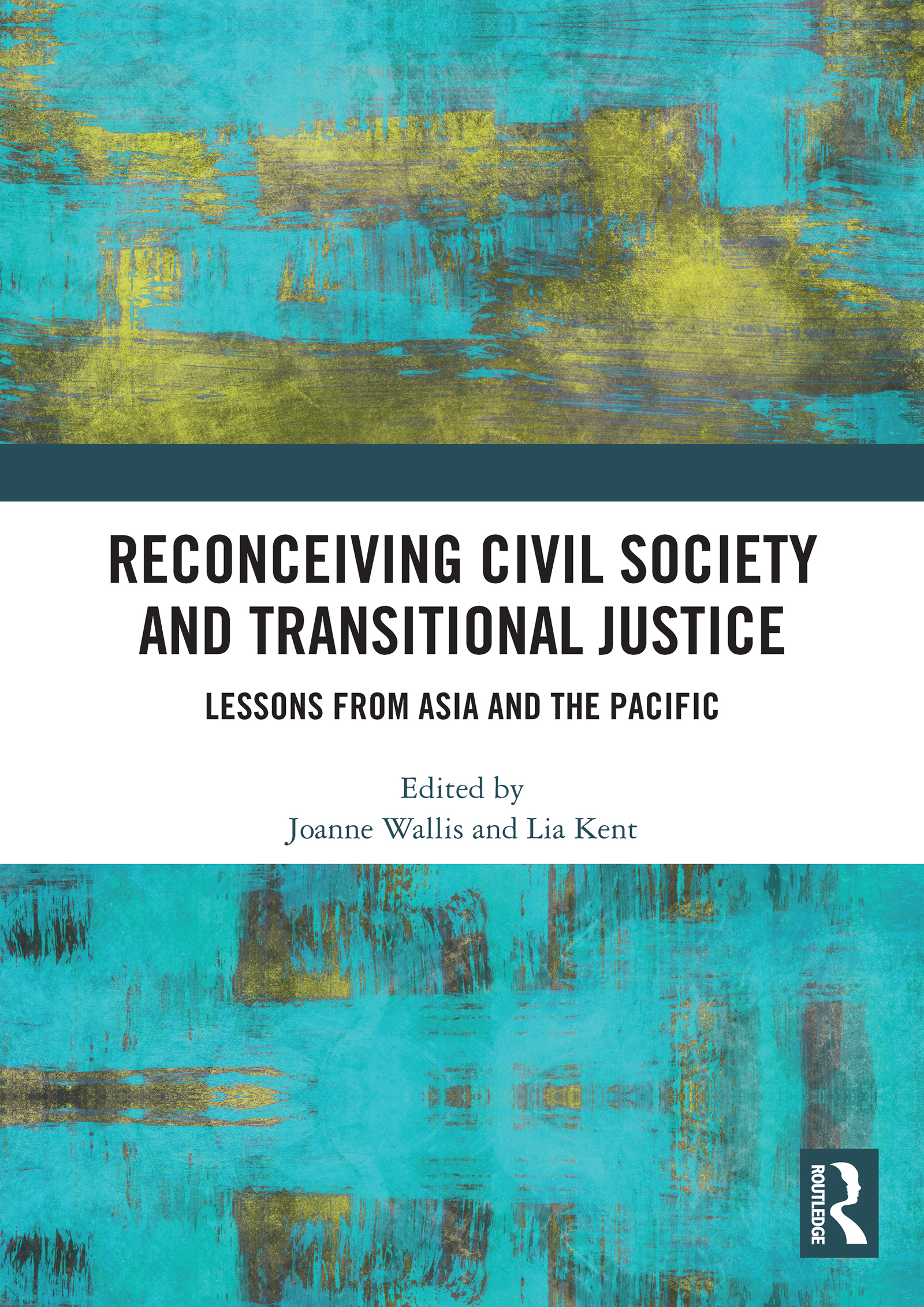
Reconceiving Civil Society and Transitional Justice Reconceiving Civil Society and Transitional Justice examines the role of civil society in transitional justice, exploring the forms of civil society that are enabled or disabled by transitional justice processes and the forms of transitional justice activity that are enabled and disabled by civil society actors. Although civil society organisations play an integral role in the pursuit of transitional justice in conflict-affected societies, the literature lacks a comprehensive conceptualisation of the diversity and complexity of these roles. This reflects the degree to which dominant approaches to transitional justice focus on liberal-legal justice strategies and international human rights norms. In this context, civil society organisations are perceived as intermediaries who are thought to advocate for and support formal, liberal transitional justice processes. The contributions to this volume demonstrate that the reality is more complicated; civil society can – and does – play important roles in enabling formal transitional justice processes, but it can also disrupt them. Informed by detailed fieldwork across Asia and the Pacific Islands, the contributions demonstrate that neither transitional justice or civil society should be treated as taken-for-granted concepts. Demonstrating that neither transitional justice or civil society should be treated as taken-for-granted concepts, Reconceiving Civil Society and Transitional Justice will be of great interest to scholars of Security Studies, Asian Studies, Peacebuilding, Asia Pacific, Human Rights, Reconciliation and the Politics of Memory. The chapters were originally published as a special issue of Global Change, Peace & Security. POLITICAL SCIENCE,General

The Inter-American Human Rights System At the time of the adoption of the American Declaration on the Rights and Duties of Man in 1948, there was little indication that the Declaration would ultimately yield a highly institutionalized system comprised of a quasi-judicial Inter-American Commission and an authoritative Inter-American Court of Human Rights. Today, however, the Inter-American Human Rights System (IAHRS) has emerged as a central actor in the global human rights regime. This comprehensive volume explores the institutional changes and transformations that the IAHRS has undergone since its creation, offering contributions and insights from a variety of disciplines including history, law, and political science. The book shows how institutional change has affected and been affected by the System’s normative leanings, rules of procedure and institutional design, as well as by the position of the IAHRS within the broader landscape of the Americas. The authors examine institutional change from a variety of angles, including the process of change in historical context, normative and legal developments, and the dynamic relationship between the IAHRS and other regional and international human rights institutions. This book was originally published as a special issue of The International Journal of Human Rights. POLITICAL SCIENCE,General
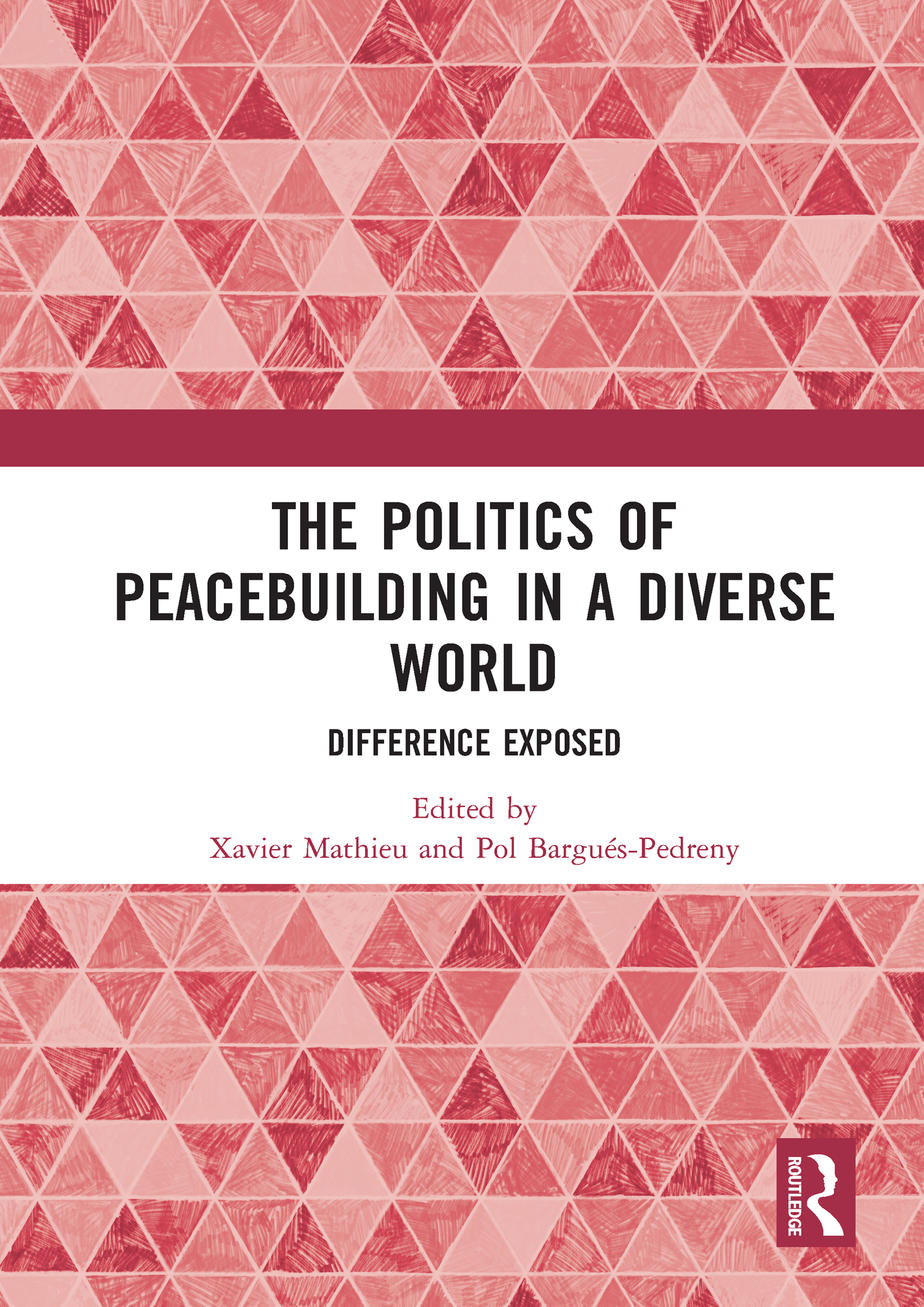
The Politics of Peacebuilding in a Diverse World This book challenges the understanding of ‘difference’ in the field of peacebuilding and offers new ways to consider diversity in the context of international interventions. International peacebuilding as a practice and academic field has always been embroiled in the ‘problem’ of difference. For mainstream scholars and policy-makers, local views, histories, and cultural codes are often seen as an obstacle on the way to peace. For critical scholars, international interventions have failed because of the very superficial attention given to the needs, values, and experience of the people in post-conflict societies. Yet the current proposals of hybrid peace and emancipation seem to reproduce Eurocentric lenses and problematic binaries. Differently inspired by feminist, post-structuralist, and new materialist perspectives, the authors assembled in this volume give sustained attention to the theorisation and practice of difference. Taken together, these contributions show that differences are always multidimensional, non-essential, and are reflections of broader power and gender inequalities. This book thus makes a major contribution to the field of critical peacebuilding by revisiting the ‘problem’ of difference. This book was originally published as a special issue of the Journal of Intervention and Statebuilding. POLITICAL SCIENCE,General
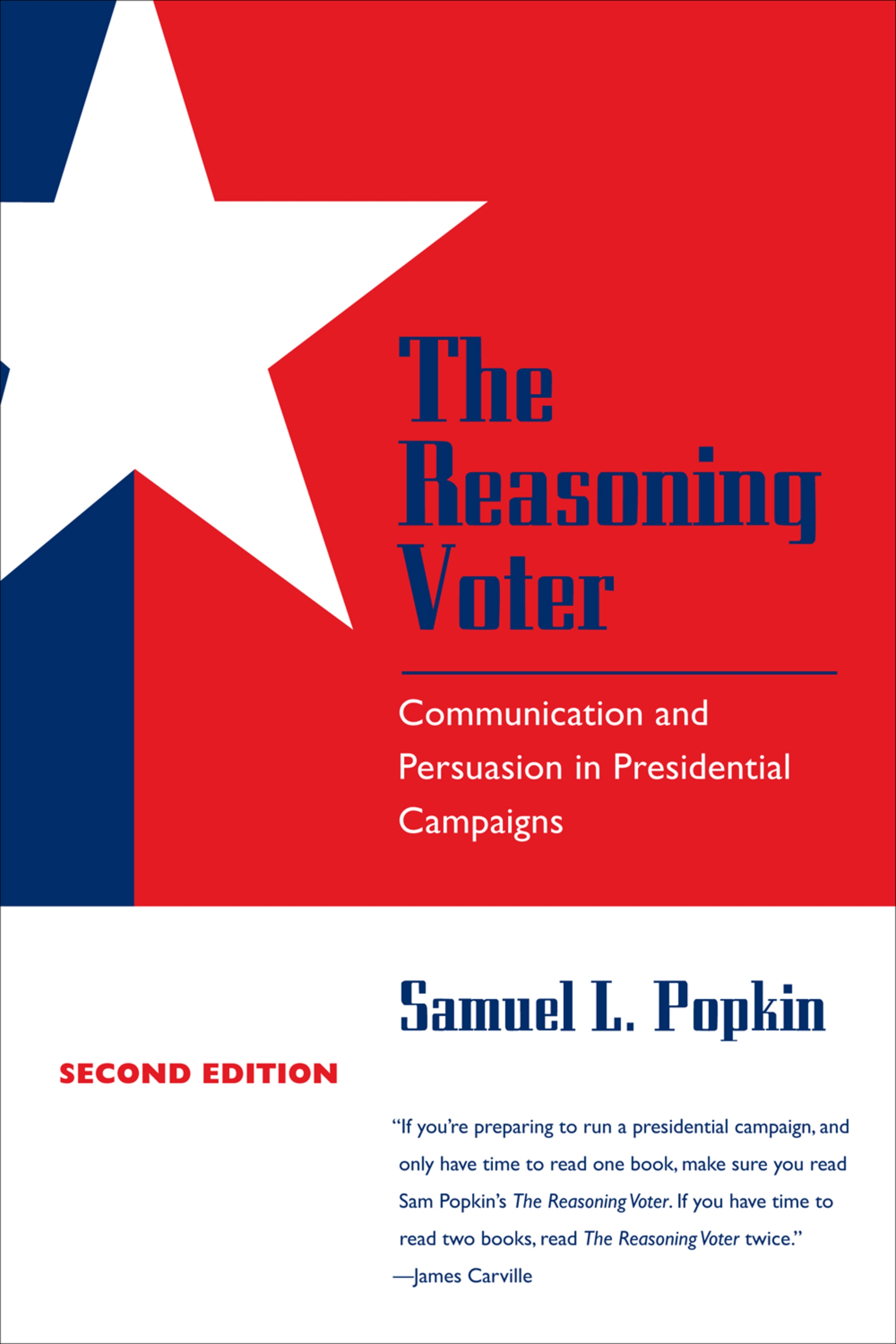
The Reasoning Voter The Reasoning Voter is an insider's look at campaigns, candidates, media, and voters that convincingly argues that voters make informed logical choices. Samuel L. Popkin analyzes three primary campaigns—Carter in 1976; Bush and Reagan in 1980; and Hart, Mondale, and Jackson in 1984—to arrive at a new model of the way voters sort through commercials and sound bites to choose a candidate. Drawing on insights from economics and cognitive psychology, he convincingly demonstrates that, as trivial as campaigns often appear, they provide voters with a surprising amount of information on a candidate's views and skills. For all their shortcomings, campaigns do matter. "Professor Popkin has brought V.O. Key's contention that voters are rational into the media age. This book is a useful rebuttal to the cynical view that politics is a wholly contrived business, in which unscrupulous operatives manipulate the emotions of distrustful but gullible citizens. The reality, he shows, is both more complex and more hopeful than that."—David S. Broder, The Washington Post POLITICAL SCIENCE,General

International Relations from the Global South This exciting new textbook challenges the implicit notions inherent in most existing International Relations (IR) scholarship and instead presents the subject as seen from different vantage points in the global South. Divided into four sections, (1) the IR discipline, (2) key concepts and categories, (3) global issues and (4) IR futures, it examines the ways in which world politics have been addressed by traditional core approaches and explores the limitations of these treatments for understanding both Southern and Northern experiences of the "international." The book encourages readers to consider how key ideas have been developed in the discipline, and through systematic interventions by contributors from around the globe, aims at both transforming and enriching the dominant terms of scholarly debate. This empowering, critical and reflexive tool for thinking about the diversity of experiences of international relations and for placing them front and center in the classroom will help professors and students in both the global North and the global South envision the world differently. In addition to general, introductory IR courses at both the undergraduate and graduate levels it will appeal to courses on sociology and historiography of knowledge, globalization, neoliberalism, security, the state, imperialism and international political economy. POLITICAL SCIENCE,General
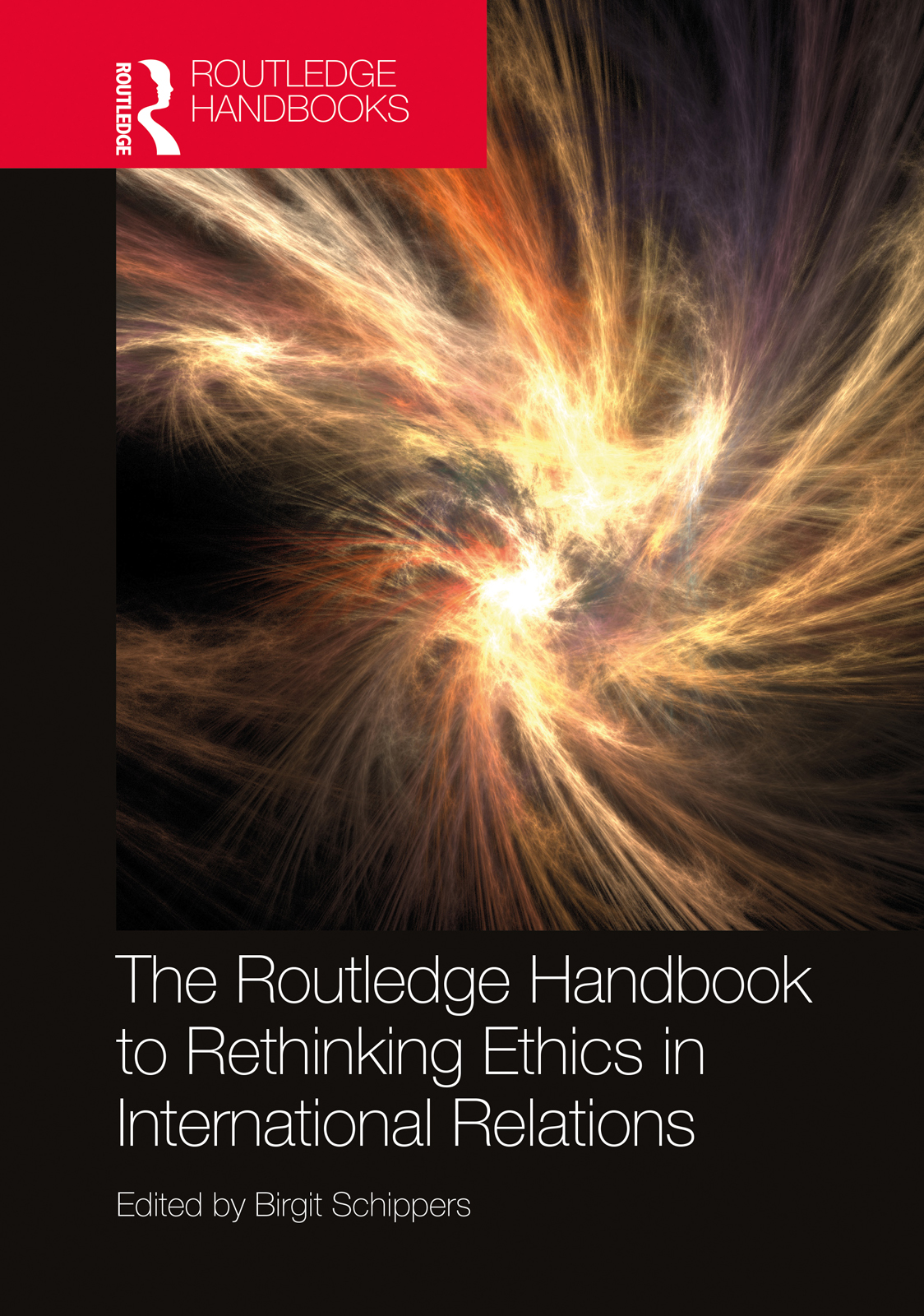
The Routledge Handbook to Rethinking Ethics in International Relations Discussing cutting-edge debates in the field of international ethics, this key volume builds on existing work in the normative study of international relations. It responds to a substantial appetite for scholarship that challenges established approaches and examines new perspectives on international ethics, and that appraises the ethical implications of problems occupying students and scholars of international relations in the twenty-first century. The contributions, written by a team of international scholars, provide authoritative surveys and interventions into the field of international ethics. Focusing on new and emerging ethical challenges to international relations, and approaching existing challenges through the lens of new theoretical and methodological frameworks, the book is structured around five themes: • New directions in international ethics • Ethical actors and practices in international relations • The ethics of climate change, globalization, and health • Technology and ethics in international relations • The ethics of global security Interdisciplinary in its scope, this book will be an important resource for scholars and students in the fields of politics and international relations, philosophy, law and sociology, and a useful reference for anyone who wishes to acquire ‘ethical competence’ in the area of international relations. POLITICAL SCIENCE,General
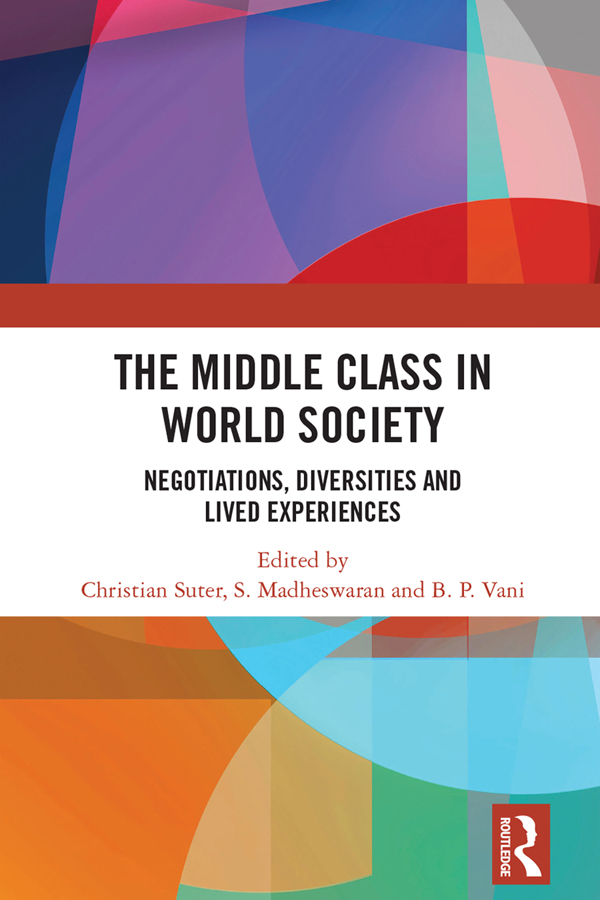
The Middle Class in World Society This volume delves into the study of the world’s emerging middle class. With essays on Europe, the United States, Africa, Latin America, and Asia, the book studies recent trends and developments in middle class evolution at the global, regional, national, and local levels. It reconsiders the conceptualization of the middle class, with a focus on the diversity of middle class formation in different regions and zones of world society. It also explores middle class lifestyles and everyday experiences, including experiences of social mobility, feelings of insecurity and anxiety, and even middle class engagement with social activism. Drawing on extensive fieldwork and in-depth interviews, the book provides a sophisticated analysis of this new and rapidly expanding socioeconomic group and puts forth some provocative ideas for intellectual and policy debates. It will be of importance to students and researchers of sociology, economics, development studies, political studies, Latin American studies, and Asian Studies. POLITICAL SCIENCE,General
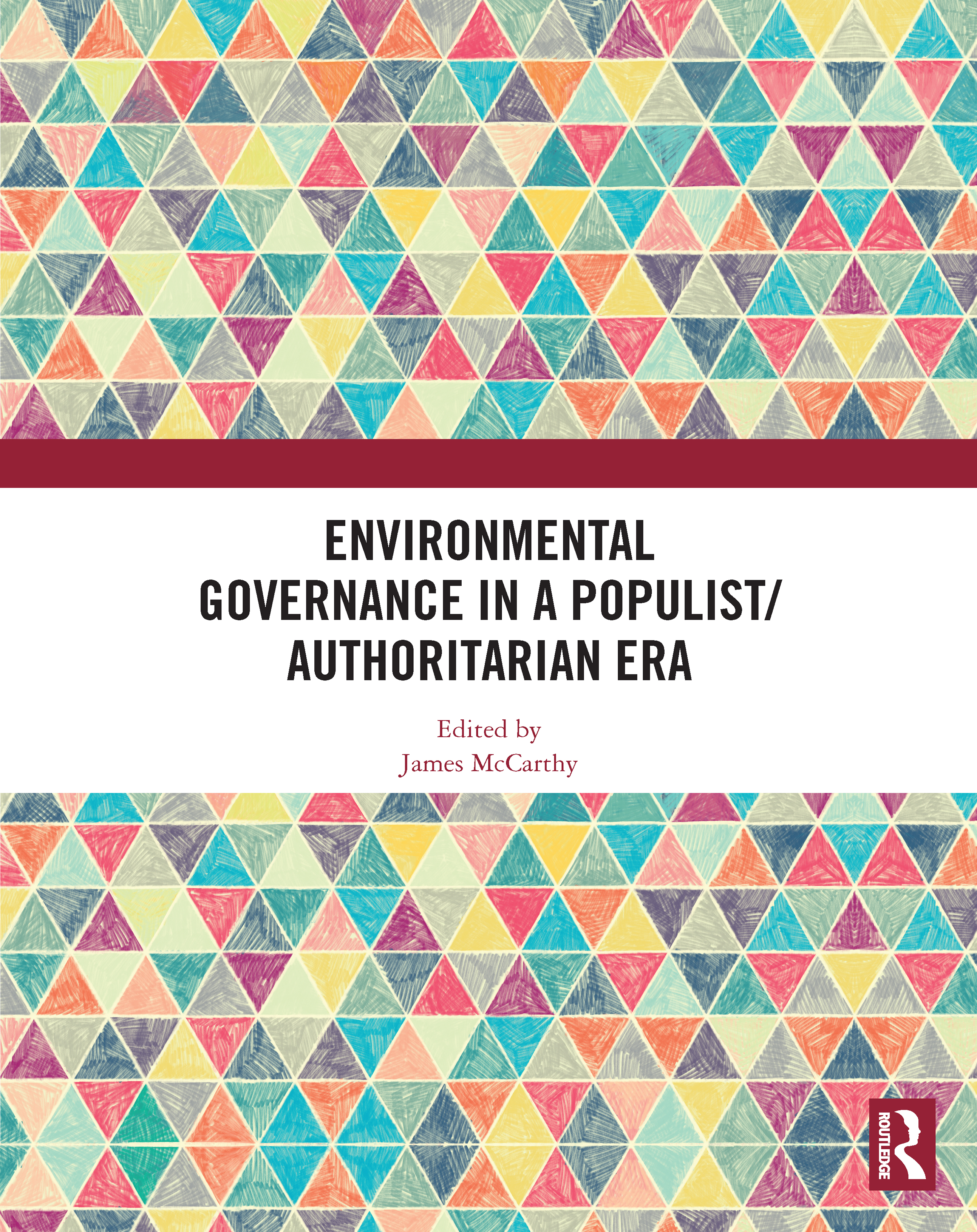
Environmental Governance in a Populist/Authoritarian Era This volume explores the many and deep connections between the widespread rise of authoritarian leaders and populist politics in recent years, and the domain of environmental politics and governance – how environments are known, valued, and managed; for whose benefit; and with what outcomes. The volume is explicitly international in scope and comparative in design, emphasizing both the differences and commonalties to be seen among contemporary authoritarian and populist political formations and their relations to environmental governance. Prominent themes include the historical roots of and precedents for environmental governance in authoritarian and populist contexts; the relationships between populism and authoritarianism and extractivism and resource nationalism; environmental politics as an arena for questions of security and citizenship; racialization and environmental politics; the politics of environmental science and knowledge; and progressive political alternatives. In each domain, using rich case studies, contributors analyse what differences it makes when environmental governance takes place in authoritarian and populist political contexts. This book was originally published as a special issue of Annals of the American Association of Geographers. POLITICAL SCIENCE,General
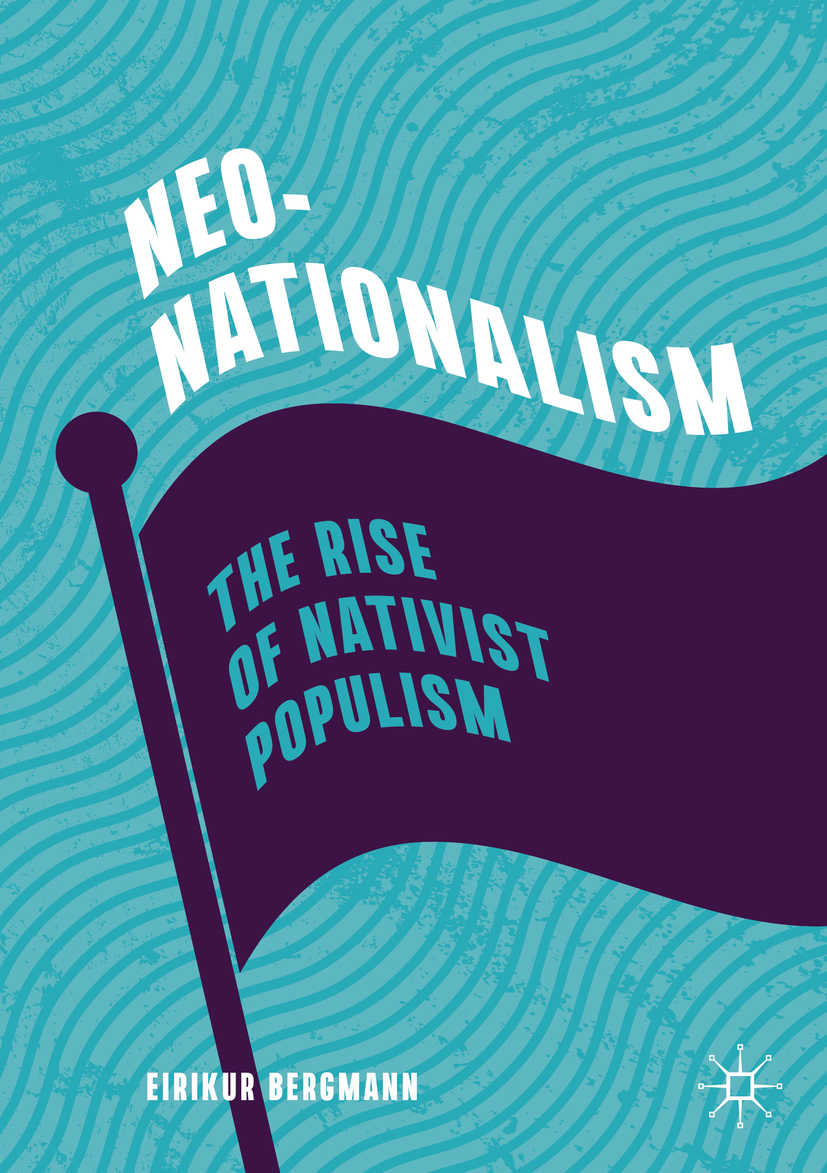
Neo-Nationalism This book maps three waves of nativist populism in the post-war era, emerging into contemporary Neo-Nationalism. The first wave rose in the wake of the Oil Crisis in 1972. The second was ignited by the Collapse of Communism in 1989, spiking with the 9/11 terrorist attacks. The third began to emerge after the Financial Crisis of 2008, soaring with the Refugee Crisis of 2015. Whether the Coronavirus Crisis of 2020 will lead to the rise of a fourth wave remains to be seen. The book traces a move away from liberal democracy and towards renewed authoritative tendencies on both sides of the Atlantic. It follows the mainstreaming of formerly discredited and marginalized politics, gradually becoming a new normal. By identifying common qualities of Neo-Nationalism, the book frames a threefold claim of nativist populists in protecting the people: discursively creating an external threat, pointing to domestic traitors, and positioning themselves as the true defenders of the nation. POLITICAL SCIENCE,General

Contemporary Preventive Diplomacy This book offers an explanation and evaluation of preventative diplomacy in an age of increasing precariousness. It emphasises the importance of pursuing diplomacy and human security in connection with the Sustainable Development Goals (SDG) which promote development grounded in peace, justice, and universal respect for human rights. It explores and uncovers efforts to set up diplomatic channels designed to ensure relations between the great powers, intra- and inter-state conflict, terrorism and weapons of mass destruction, human rights, and the global watch over human security do not escalate out of control. Discussing evolving tensions between the United States and China, and the United States and Russia, this book recalls past examples of preventive diplomacy between them, and explores ideas for the exercise of preventive diplomacy in the future. Presenting evidence that contemporary preventive diplomacy is pursued not only by international or regional officials but also by nongovernmental organizations and individuals, the book emphasises the need to pursue and enhance a comprehensive effort to realize SDG16 and human security. The book contains a range of practical recommendations to improve preventive diplomacy and provides a unique optic into understanding the threats facing the planet. It will be of interest to scholars and students of diplomacy, security studies, global governance and practitioners in government and international organisations.. POLITICAL SCIENCE,General
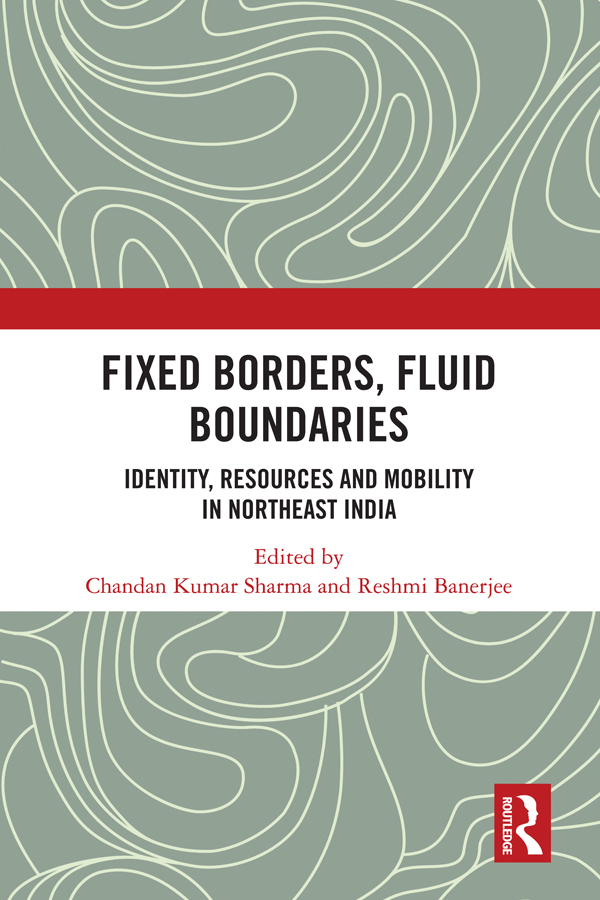
Fixed Borders, Fluid Boundaries This book provides an understanding of the challenges in Northeast India in terms of the nature of flows and ruptures in the daily lives of people. It brings together multiple and interconnected issues of identity, development, environment, migration, land alienation and policy impacts to the forefront. Northeast India’s history is affected both by internal dynamic processes, as are its linkages with adjoining countries, marked by a fluid movement of people and goods across porous borders. The book explores how the region has emerged as a resource frontier for the global markets, yet its resource mobilization has led to disparity within the region. The volume discusses key themes concerning the region such as the processes of development and people’s resistance; underdevelopment in the peripheral areas; resource flow and conflict; community response and local agency; state and customary practices; politics of land and citizenship; development-induced dispossession; human mobility, immigration and conflict; the notion of "outsiders"; inter-state border conflict; and spatial connections. Rich in empirical data, the volume will be relevant and useful for students and researchers of development studies, Northeast India studies, sociology, political science, border and migration studies, public policy, peace and conflict studies, as well as practitioners and policymakers. POLITICAL SCIENCE,General
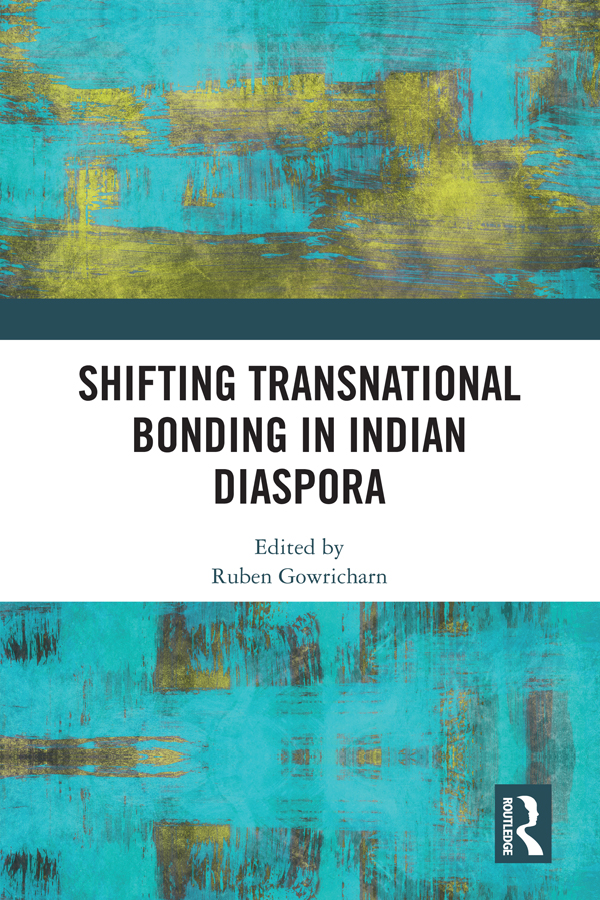
Shifting Transnational Bonding in Indian Diaspora This volume examines Indian diasporic communities in various countries including the United Kingdom, Trinidad, Portugal, Netherlands, and Fiji, among others, and presents new perspectives on the shifting nature of Indian transnationalism. The book: Discusses how migrant communities reinforce the diaspora and retain a group identity, while at the same time maintaining a bond with their homelands; Highlights new tendencies in the configuration of Indian transnationalism, especially cultural entanglements with the host countries and the differentiation of homelands; Studies forces affecting bonding among these communities such as global and local encounters, glocalisation, as well as economic, political, and cultural changes within the Indian state and the wider Indian diaspora. Featuring a diverse collection of essays rooted in robust fieldwork, this volume will be of great importance for students and researchers of diaspora studies, globalization and transnational migration, cultural studies, minority studies, sociology, political studies, international relations, and South Asian studies. POLITICAL SCIENCE,General

Reinventing the Austin City Council Until recently, Austin, the progressive, politically liberal capital of Texas, elected its city council using a not-so-progressive system. Candidates competed citywide for seats, and voters could cast ballots for as many candidates as there were seats up for election. However, this approach disadvantages the representation of geographically-concentrated minority groups, thereby—among other things—preventing the benefits of growth from reaching all of the city’s communities. Reinventing the Austin City Council explores the puzzle that was Austin’s reluctance to alter its at-large system and establish a geographically-based, single-member district system. Ann Bowman chronicles the repeated attempts to change the system, the eventual decision to do so, and the consequences of that change. In the process, she explores the many twists and turns that occurred in Austin as it struggled to design a fair system of representation. Reinventing the Austin City Council assesses the impact of the new district system since its inception in 2014. Austin’s experience ultimately offers a political lesson for creating institutional change. POLITICAL SCIENCE,General
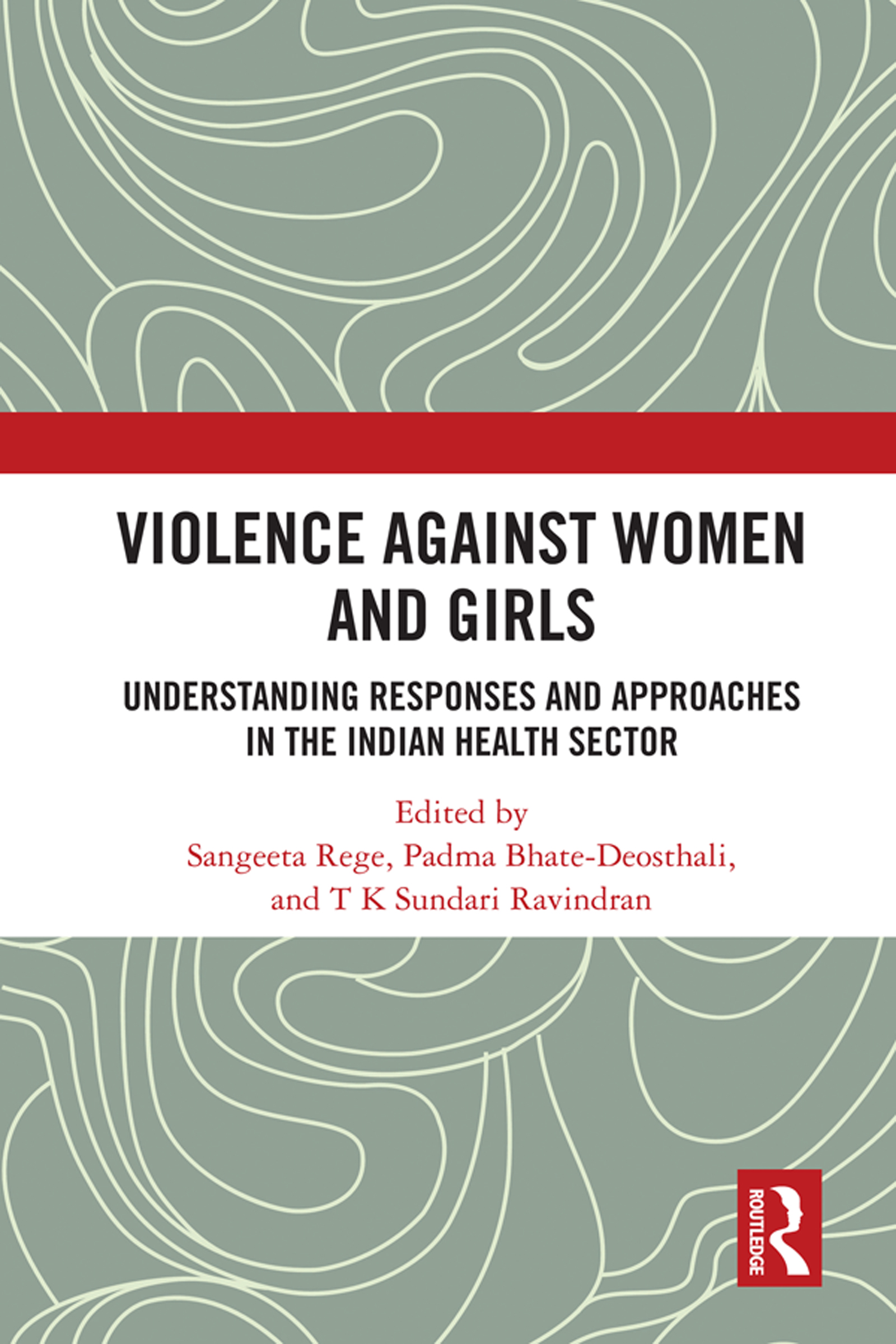
Violence against Women and Girls This book discusses the pervasiveness of violence against women (VAW) in India and traces its evolution as a public health concern. It highlights the fundamental relationship between health and violence and identifies institutional gaps, which hinder comprehensive healthcare and support to VAW survivors. The volume brings together in-depth case studies from various states and civil society organisations on their initiatives to help bring adequate support and health services to women affected by VAW. These include engagement with hospitals to increase awareness and sensitivity among health service providers and community-run health clinics for marginalised women. The book documents the mobilising efforts of feminists, community-based organisations, state institutions, and CSOs in developing comprehensive healthcare responses and bringing violence against women into the public health discourse. It provides insights into the lack of guidelines for responding to sexual violence in medical and nursing education, and the way that the police and the justice system function in India. This book will be of interest to public health professionals, and students and researchers in public health, gender studies, social work, and sociology. It will also be useful for policymakers and for professionals working for thinktanks or CSOs working on developing health system responses to VAW. POLITICAL SCIENCE,General
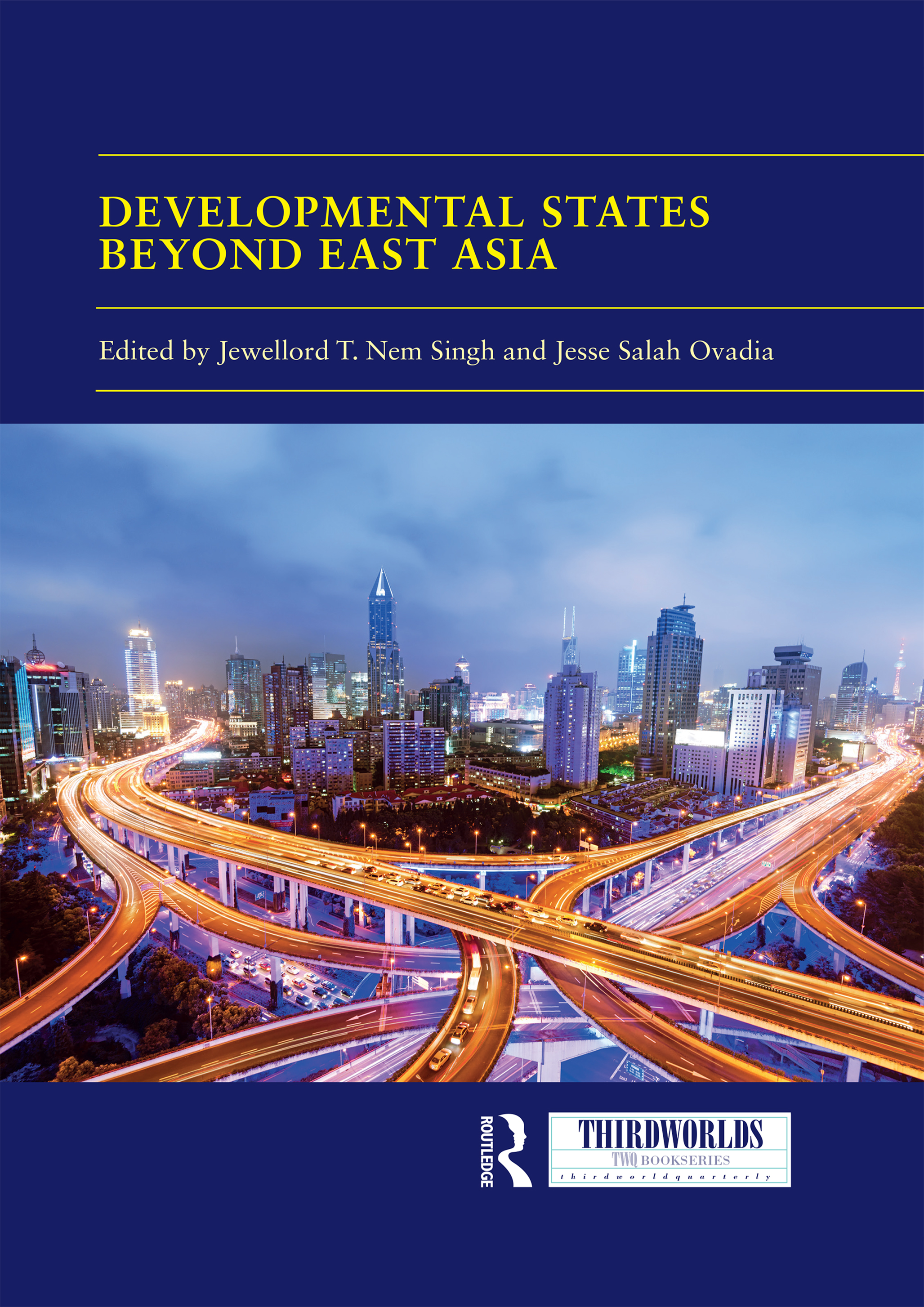
Developmental States beyond East Asia This comprehensive volume reviews recent scholarship regarding the role of the state in economic development. With a wide range of case studies of both successful and failed state-led development, the authors push the analysis of the developmental state beyond its original limitations and into the 21st century. New policies, institutional configurations, and state-market relations are emerging outside of East Asia, as new developmental states move beyond the historical experience of East Asian development. The authors argue for the continued relevance of the ‘developmental state’ and for understanding globalization and structural transformation through the lens of this approach. They further this concept by applying it to analyses of China, Latin America, and Africa, as well as to new frontiers of state-led development in Japan and the East Asian developmental states. This book expands the scope of research on state-led development to encompass new theoretical and methodological innovations and new topics such as governance, institution building, industrial policy, and the role of extractive industries. This book was originally published as a special issue of the journal Third World Quarterly. POLITICAL SCIENCE,General
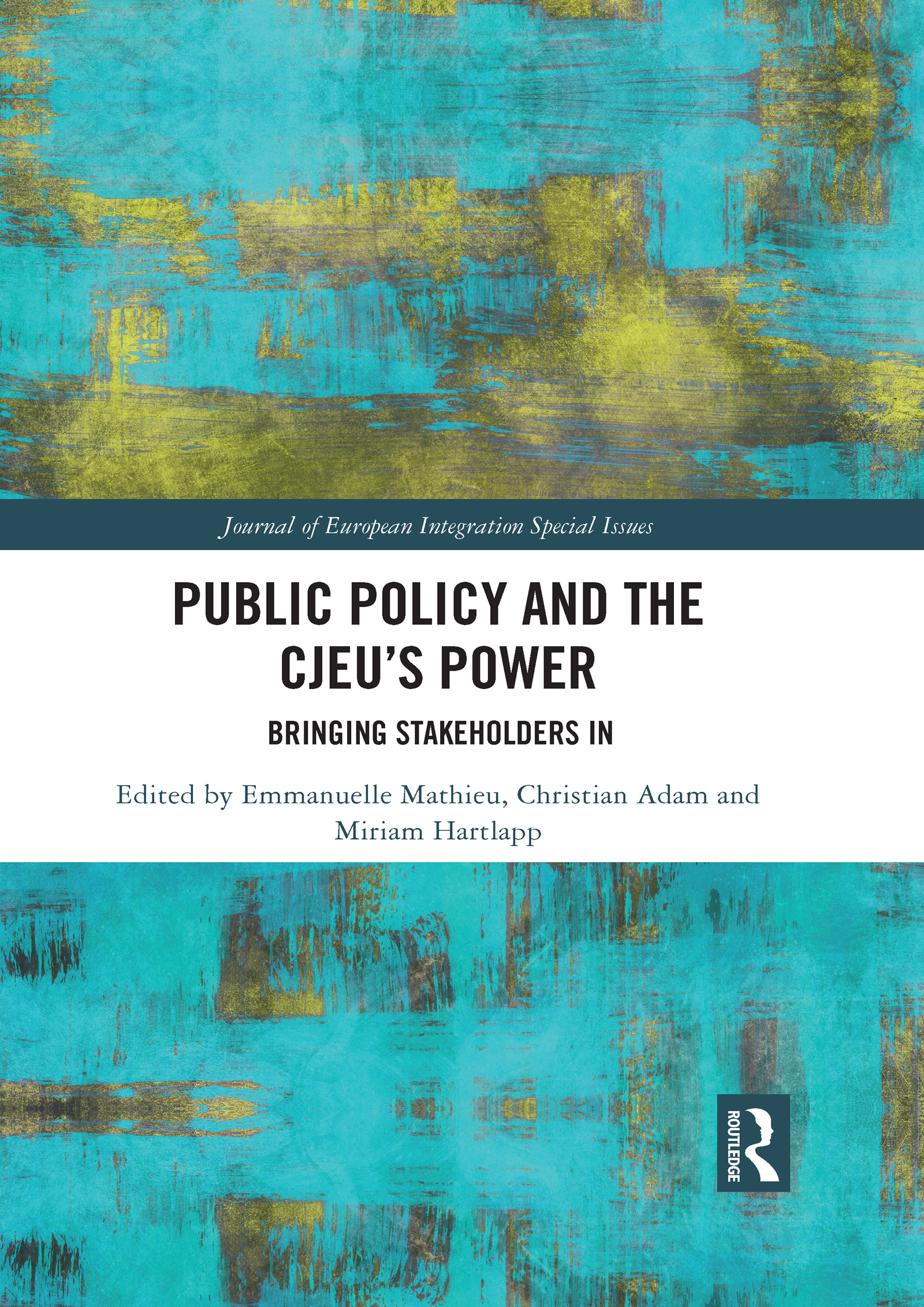
Public Policy and the CJEU’s Power Public Policy and the CJEU’s Power offers an overarching analytical framework for thinking about the impact of policy contexts on the CJEU’s influence on European public policy and the course of European integration. Thereby, it lays out a research agenda that is best described as public policy approach to studying judicial power in the European Union. The policy contexts within which actors operate do not only structure the incentives to use litigation, they also affect how strongly the implementation of court rulings relies on these policy stakeholders. Therefore, the CJEU’s power is strongly dependent on policy contexts and policy stakeholders. This argument is illustrated by a wide variety of empirical analyses covering the three major types of legal actions before the CJEU (infringement proceedings, preliminary rulings and annulments), a wide variety of policy fields (e.g. competition law, internal market regulation, common agriculture policy, social policies, foreign policy), and different types of policy stakeholders (e.g. public, private, subnational, national and European stakeholders). Using this rich empirical material, the book provides an analytic framework for thinking about how policy contexts influence the CJEU’s impact. Bringing together expert contributions, Public Policy and the CJEU’s Power will be of great interest and use to scholars working on the European Union, law and politics and public policy. The chapters were originally published as a special issue in the Journal of European Integration. POLITICAL SCIENCE,General

The Transformation of Targeted Killing and International Order This comprehensive volume addresses the important question of whether and how the current transformation of targeted killing is transforming the global international order. The age-old practice of targeted killing has undergone a profound transformation since the turn of the millennium. States resort to it more frequently, especially in the context of counter-terrorism operations. The rapid development of surveillance and drone technologies facilitates targeted-killing missions, and states are starting to slowly abandon their policies of secrecy and denial with regard to this form of violence. To answer this question, the volume introduces a theoretical framework that conceives the maintenance and transformation of international order as a dynamic, triangular process between violence, discourse, and the institutions that make up the international order. It then sheds light on different parts of this triangular process: the reinterpretation of international law to legitimize targeted killing, the contestation between state and non-state actors over the development of a new targeted-killing norm, the emergence of targeted killing in the context of changes in the broader normative context of international order, and the impact of new technologies, in particular autonomous weapons systems, on the future of targeted-killing practices and international order. This book was originally published as a special issue of Contemporary Security Policy. POLITICAL SCIENCE,General

Parliaments in EU Economic Governance This book considers national parliaments’ and the European Parliament’s role in European Union (EU) economic governance. It examines the recent strengthening of parliamentary involvement, limitations to improvements, and where and how democratic deficits still exist. It also provides the basis for some reflections concerning possible future evolutions and improvements to EU economic governance. The EU’s economic governance framework has been significantly strengthened as a response to the 2008 economic and financial crisis, and the establishment of a new Banking Union in 2013. It is thus key to determine whether these additional transfers of powers to the EU level have been accompanied by an equivalent empowerment of the national and European legislatures, allowing them to ensure adequate democratic legitimation. The chapters comprehensively re-examine the democratic (throughput) legitimacy of, and within, the EU’s economic governance by focusing on national parliaments, on the European Parliament, and on mechanisms for interparliamentary cooperation. This book was originally published as a special issue of the Journal of European Integration. POLITICAL SCIENCE,General

Democratic Representation in Multi-level Systems This comprehensive volume studies the vices and virtues of regionalisation in comparative perspective, including countries such as Belgium, Germany, Spain, and the UK, and discusses conditions that might facilitate or hamper responsiveness in regional democracies. It follows the entire chain of democratic responsiveness, starting from the translation of citizen preferences into voting behaviour, up to patterns of decision-making and policy implementation. Many European democracies have experienced considerable decentralisation over the past few decades. This book explores the key virtues which may accompany this trend, such as regional-level political authorities performing better in understanding and implementing citizens’ preferences. It also examines how, on the other hand, decentralisation can come at a price, especially since the resulting multi-level structures may create several new obstacles to democratic representation, including information, responsibility and accountability problems. This book was originally published as a special issue of the journal West European Politics. POLITICAL SCIENCE,General

Stabilization as the New Normal in International Interventions Stabilization as the New Normal in International Interventions provides the first comprehensive analysis of stabilization, which constitutes the new reference point for international intervention in unruly parts of the Global South. The notion of ‘stabilization’ and the practice of ‘stability operations’ experienced a revival over the last decade. The United Nations, the European Union, NATO, as well as most member states of the Organisation for Economic Cooperation and Development have embraced these terms in their foreign policy bureaucracies. The general disillusionment with the achievements of large-scale peacebuilding operations in countries like Afghanistan and Iraq, as well as the failures of the so-called Arab Springs, contributed to the success of this new discourse. Yet, while widely mentioned and endorsed, stabilization is rarely defined. This volume identifies common elements to stabilization doctrines and examines how they are applied in practice. It dissects how stabilization emerged and unfolds, how different actors adopt it and for what purposes, and how it is linked to the broader security and development discourses. Stabilization as the New Normal in International Interventions will be of great interest to scholars of Peacebuilding, International Intervention and International Relations more generally. The chapters were originally published as a special issue of Ethnopolitics. POLITICAL SCIENCE,General

Cultural Diplomacy and International Cultural Relations This book is the first in a dedicated series that explores questions of cultural diplomacy and international cultural relations. Drawing on a broad range of disciplinary perspectives, it throws new light on the function and operation of policies that seek to change attitudes, values and behaviours across national boundaries and in diverse geocultural contexts. The specific policies explored relate to ways in which sites of past violence and atrocity are deployed in strategies of soft power; to the contribution of culture to EU enlargement; to the use of the Russian language as a soft power resource; to the singularities of the Indian cultural diplomacy; to cultural diplomacy as elite legitimation; to the role of diaspora relations in European cultural diplomacy; to the use of film in post-war cultural diplomacy; and to the role assigned to culture in the Canada-EU Comprehensive Economic Trade Agreement. Scholars interested in how cultural and foreign policy intersect in widely differing national contexts will find this book an invaluable resource. It was originally published as a special issue of the International Journal of Cultural Policy. POLITICAL SCIENCE,General
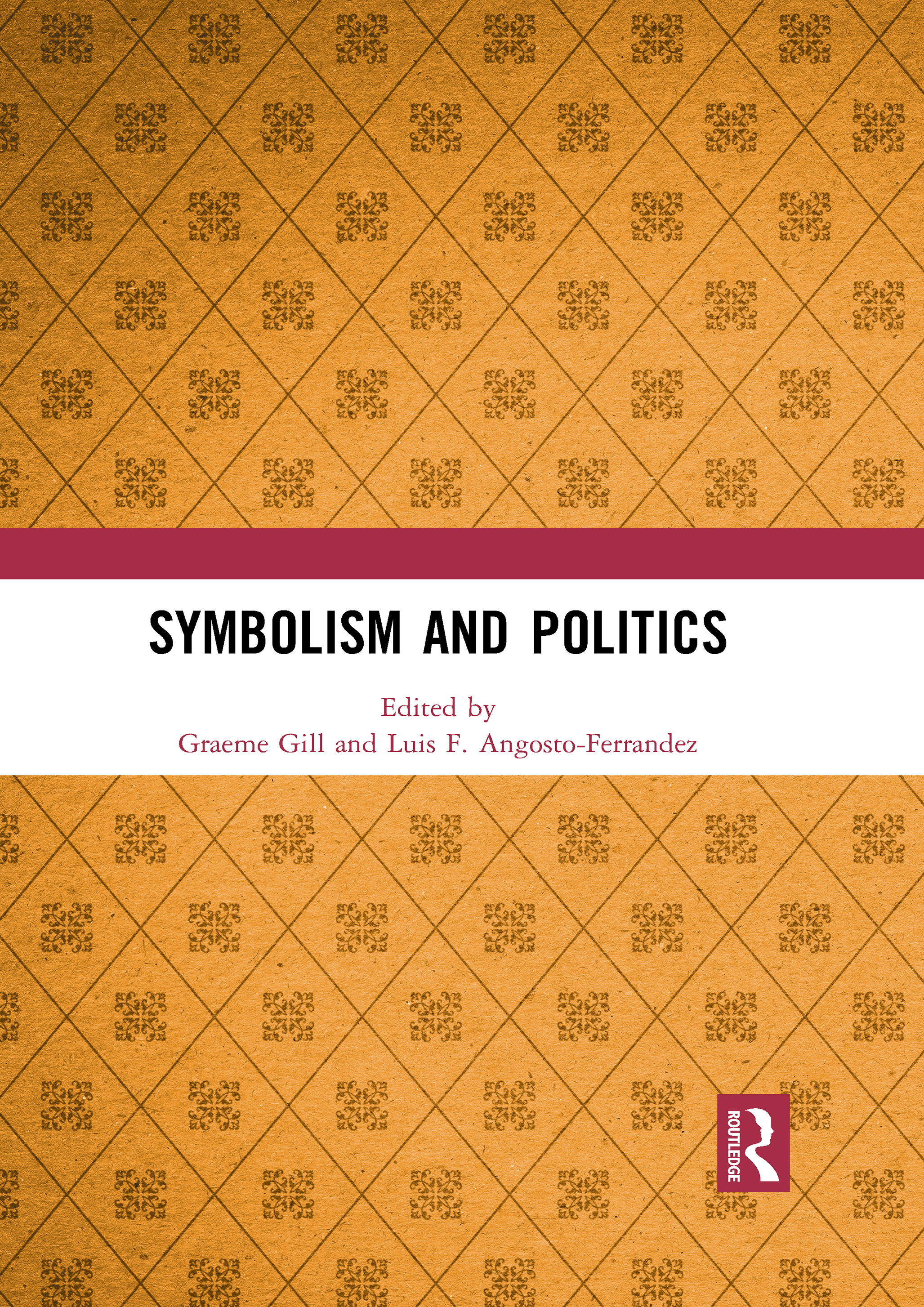
Symbolism and Politics Symbolism and Politics is a timely intervention into ongoing debates around the function of political symbols in a historical period characterized by volatile electoral behaviour, fragmented societies in search of collective identifications, and increasingly polarized political models. Symbols are central features of organized human life, helping to define perception, shaping the way we view the world and understand what goes on within it. But, despite this key role in shaping understanding, there is never a single interpretation of a symbol that everyone within the community will accept, and the way in which symbols can mobilize antagonistic political factions demonstrates that they are as much a central element in power struggles as they are avenues to facilitate processes of identification. This dual potential is the object of discussion in the chapters of this book, which sheds new light on our understanding of the political function of symbols in a historical period. Symbolism and Politics will be of great interest to scholars working on Political Symbols, Nationalism, Regime Change and Political Transitions. The chapters originally published as a special issue of Politics, Religion & Ideology. POLITICAL SCIENCE,General

Global Debt Dynamics This comprehensive volume explores debt dynamics and the intensification of debt crises across the globe, bringing together several recent but underexplored debt crises from different regional and socioeconomic contexts. Using detailed case studies, the authors recast the perils of debt-based growth in the context of regional/global imbalances; not to advocate ‘one-size-fits-all’ reforms, but to point to the need for accommodating diversity. They examine how current economic developments put developing and developed countries under new strain. They also interrogate the opportunities and challenges generated for developing countries by the new development finance landscape and newly (re)emerged geopolitical tensions. The book also explores the inability of existing dominant structures and thinking to effectively manage the multiple facets of the ongoing global debt crisis, pointing to responses that exacerbate rather than address unsustainable debt dynamics. The authors illustrate the adverse effects of ad hoc crisis management mechanisms which are not fit for purpose, and indicate the negative consequences that existing policies may have for democracy. They then put forward a framework for alternative thinking as well as concrete ideas on what needs to be done, in response. This book will be of great interest to students, scholars and professionals in the field of global debt studies. It was originally published as a special issue of the online journal Third World Thematics. POLITICAL SCIENCE,General
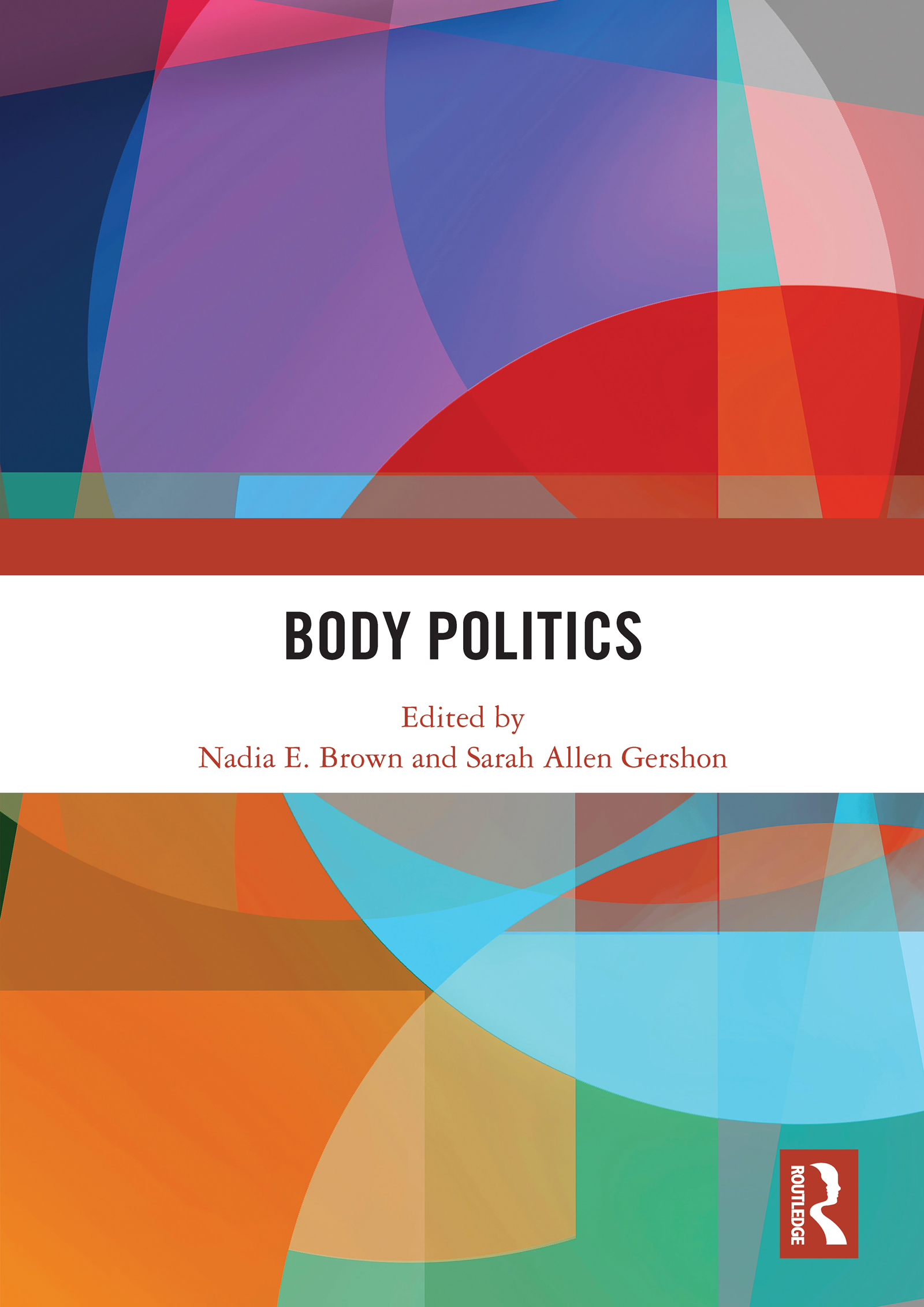
Body Politics The politics of the body is often highly contested, culturally specific, and controlled, and this book calls our attention to how bodies are included or excluded in the polity. With governments regulating bodies in ways that mark the political boundaries of who is a citizen, worthy of protection and rights, as well as those who transgress socially proscribed norms, the contributors to this volume offer a systematic investigation of both theoretical and empirical account of bodily differences broadly defined. These chapters, diverse in both the populations and the political behaviours examined, as well as the methodological approaches employed, showcase the significance of body politics in a way few edited works in political science currently do. Arguing that the body is an important site to understand power relations, this book will be of interest to those studying the unequal application of rights to women, racial and ethnic minorities, the LGBTQ community, and people with disabilities. This book was originally published as a special issue of Politics, Groups, and Identities. POLITICAL SCIENCE,General
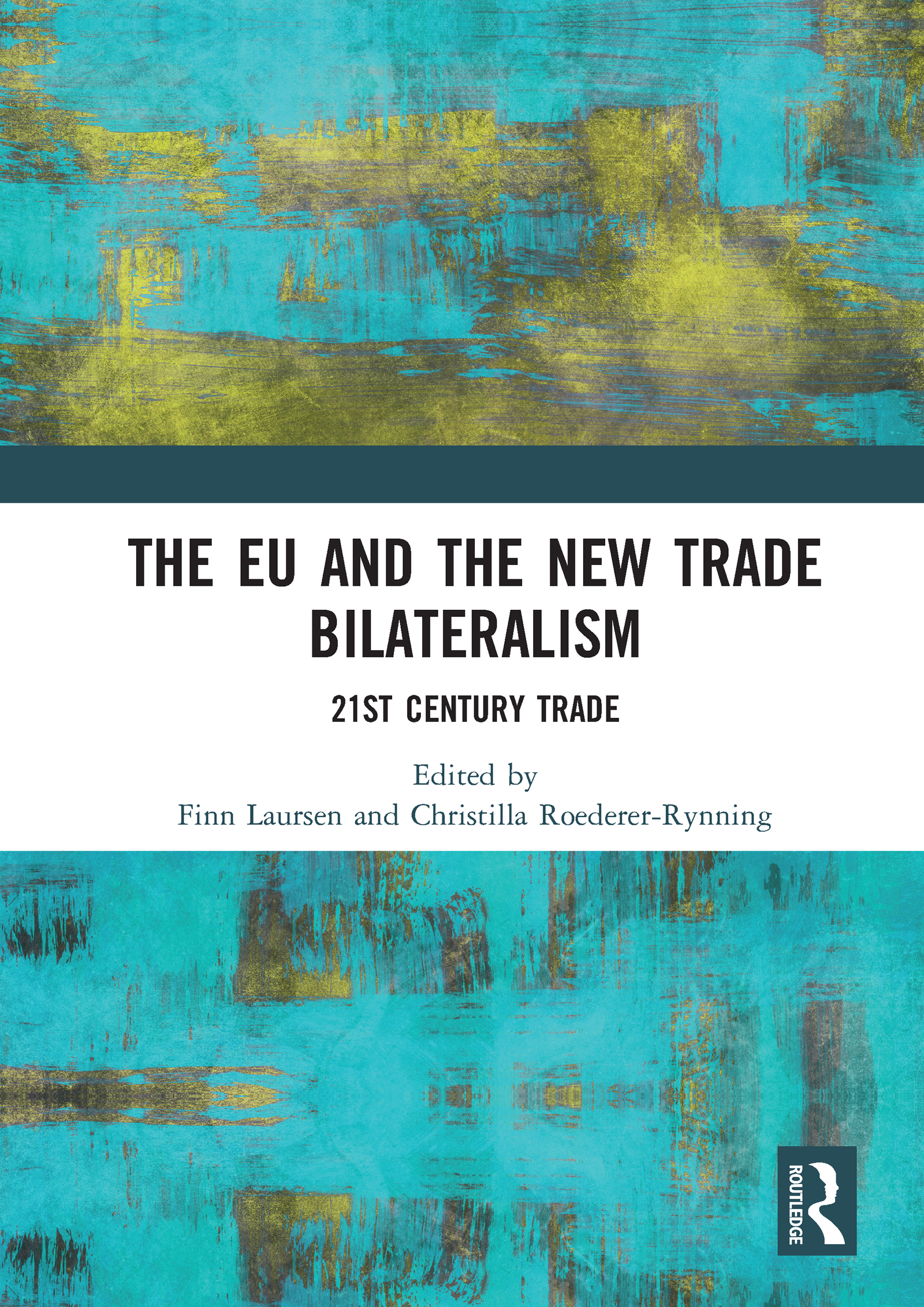
The EU and the New Trade Bilateralism International trade policy, including the trade policies of the European Union (EU), has become controversial in recent years. This book illuminates the politicised process of the EU’s contemporary trade negotiations. The book uses the notion of ‘contentious market regulation’ to examine contemporary EU Free-Trade Agreements (FTAs) with industrialised countries: the Transatlantic Trade and Investment Partnership with the USA (TTIP), the Comprehensive Economic and Trade Agreement with Canada (CETA), the EU-South Korea Agreement (KOREU), and the EU’s agreement with Japan (EU-Japan). It also analyses cross-cutting issues affecting trade policy, such as business dimensions, social mobilisation, parliamentary assertion, and investment. This book was originally published as a special issue of the Journal of European Integration. POLITICAL SCIENCE,General
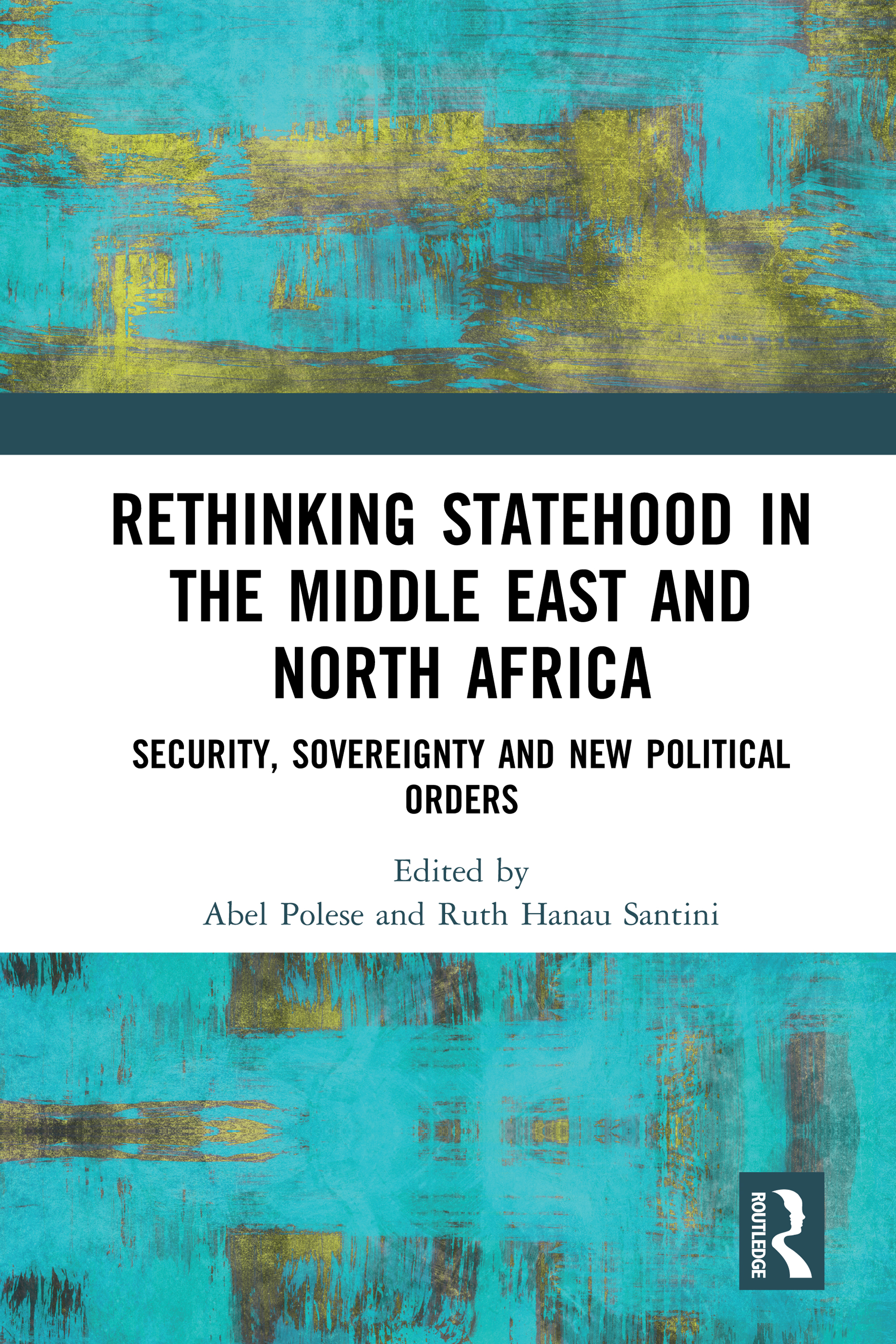
Rethinking Statehood in the Middle East and North Africa Alternative forms of government and statehood exist in the Middle East and North African regions. The chapters in this volume demonstrate this and explore the notion of power from a non-statist perspective, highlighting the limits of states and their governance. Using empirical evidence from Syria, Libya, Lebanon, Tunisia, Iraq, Yemen, and Mali, the authors explore non-standard cases where power may be retained by a state but must be shared with a number of local actors, resulting in limited statehood and hybrid governance, which leads to competition and sharing of symbolic and political power within a state. This book is intended to prompt a critical reflection on the meaning of governance. It will illuminate informal structures which deserve attention when studying governance and power dynamics within a state or a region. This book was originally published as a special issue of Small Wars & Insurgencies. POLITICAL SCIENCE,General

The Cultural Roots Of British Devolution The Cultural Roots of British Devolution is research on British Government formation. We study about Irish Home Rule Movement, History of Northern, Southern Ireland, Scottish Devolution, formation and working of assemblies, parliament etc. Moreover this book throws light on different political parties of Britain like British National Party, Respect Party, Conservative Party, Labour Party, Liberal Democrats, UK Independence Party and Women s Equality Party etc. POLITICAL SCIENCE,General
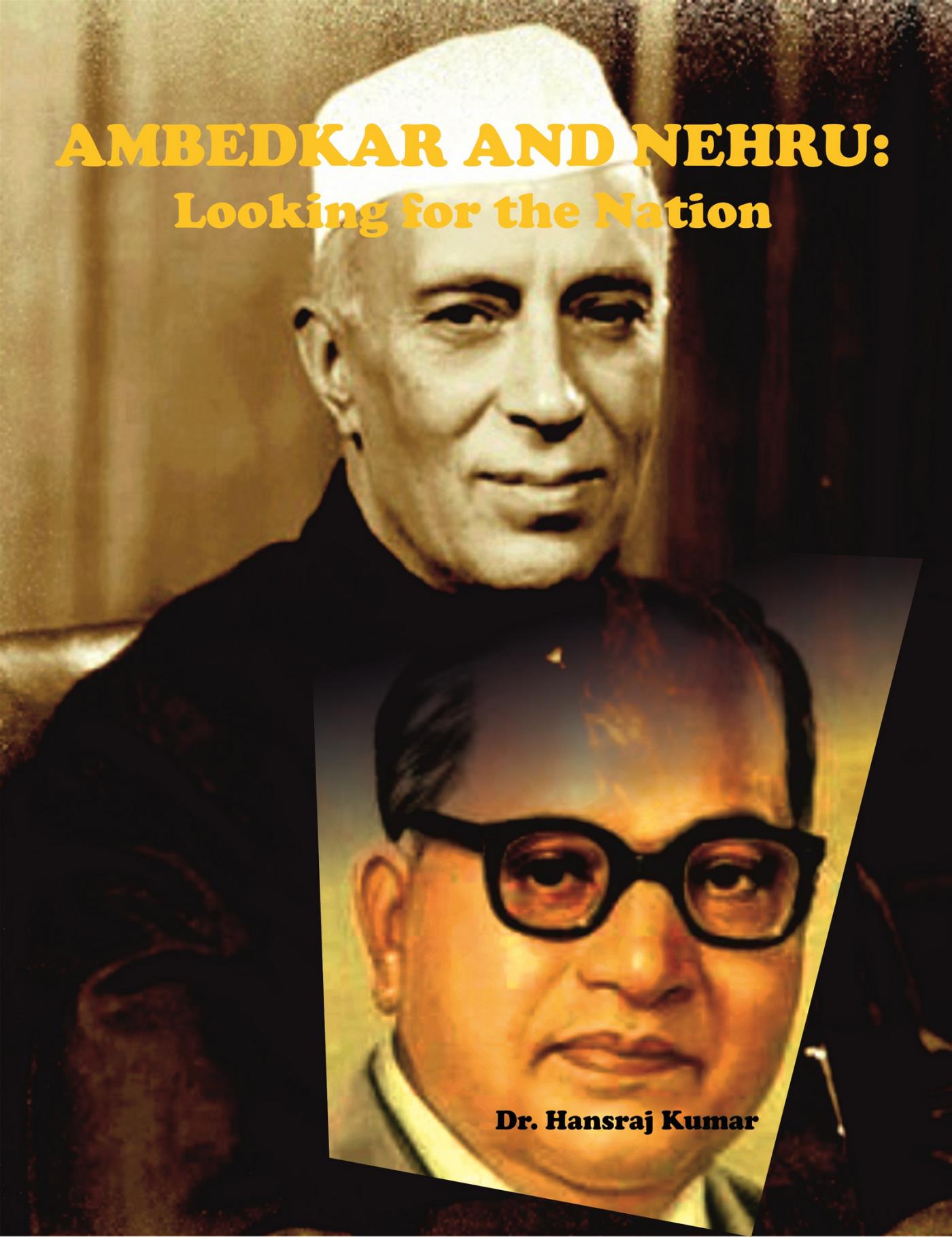
Ambedkar And Nehru Pandit Jawaharlal Nehru (November 14,1889-May 27, 1964) was a major political leader of the Congress Party, a pivotal figure in the Indian independence movement and the first Prime Minister of independent India. Nehru's greatest contribution to India in the importance that he had given to science, technology and industrialisation without which progress was impossible. He was fighting alongside the main currents of socio-cultural life in the country. He was opposed to traditions and superstitions. India had controversially opposed the partition of Palestine and the 1956 invasion of the Sinai by Israel, Britain and France, but did not oppose the Chinese occupation of Tibet and the suppression of a pro-democracy movement in Hungary by the Soviet Union. Although Nehru disavowed nuclear ambitions for India, Canada and France aided India in the development of nuclear power stations for electricity. India also negotiated an agreement in 1960 with Pakistan on the just use of the waters of seven rivers shared by the countries. Bhimrao Ramji Ambedkar (14 April 1891 - 6 December 1956), also known as Ba-basaheb, was an Indian jurist, political leader, Buddhist activist, philosopher, thinker, anthropologist, historian, orator, prolific writer, economist, scholar, editor, revolutionary and a revivalist for Buddhism in India. He was also the chief architect of the Indian Constitution. Born into a poor Mahar, then Untouchable, family, Ambedkar spent his whole life fighting against social discrimination, the system of Chaturvarna - the categorization of Hindu society into four varnas - and the Hindu caste system. He is also credited with providing a spark for the conversion of hundreds of thousands of Dalits with his Ambedkar (ite) Buddhism. Ambedkar has been honoured with the Bharat Ratna, India's highest civilian award. POLITICAL SCIENCE,General

Plea Bargaining "That relatively few criminal cases in this country are resolved by full Perry Mason-style strials is fairly common knowledge. Most cases are settled by a guilty plea after some form of negotiation over the charge or sentence. But why? The standard explanation is case pressure: the enormous volume of criminal cases, to be processed with limited staff, time and resources. . . . But a large body of new empirical research now demands that we re-examine plea negotiation. Milton Heumann's book, Plea Bargaining, strongly and explicitly attacks the case-pressure argument and suggests an alternative explanation for plea bargaining based on the adaptation of attorneys and judges to the local criminal court. The book is a significant and welcome addition to the literature. Heumann's investigation of case pressure and plea negotiation demonstrates solid research and careful analysis."—Michigan Law Review POLITICAL SCIENCE,General

Enduring Controversies in Presidential Nominating Politics Enduring Controversies in Presidential Nominating Politics retraces the more than two hundred-year history of presidential elections in the United States to provide a primer on how the process has evolved from the days of the founders, through the heyday of nominating conventions, to today’s overwhelming interest in early primaries. Original essays by the editors introduce, critique, and occasionally even refute a wide variety of historical readings including Alexander Hamilton’s defense of election procedures, excerpts of individual states’ nominations of candidates in 1824, an overview of the impact television has had on nominating conventions, and calls for a national rotating primary scheme in 2004. As a whole, the collection reveals the common threads that run through the history of the nominating process, and points out that today’s litany of complaints is not at all new. POLITICAL SCIENCE,General
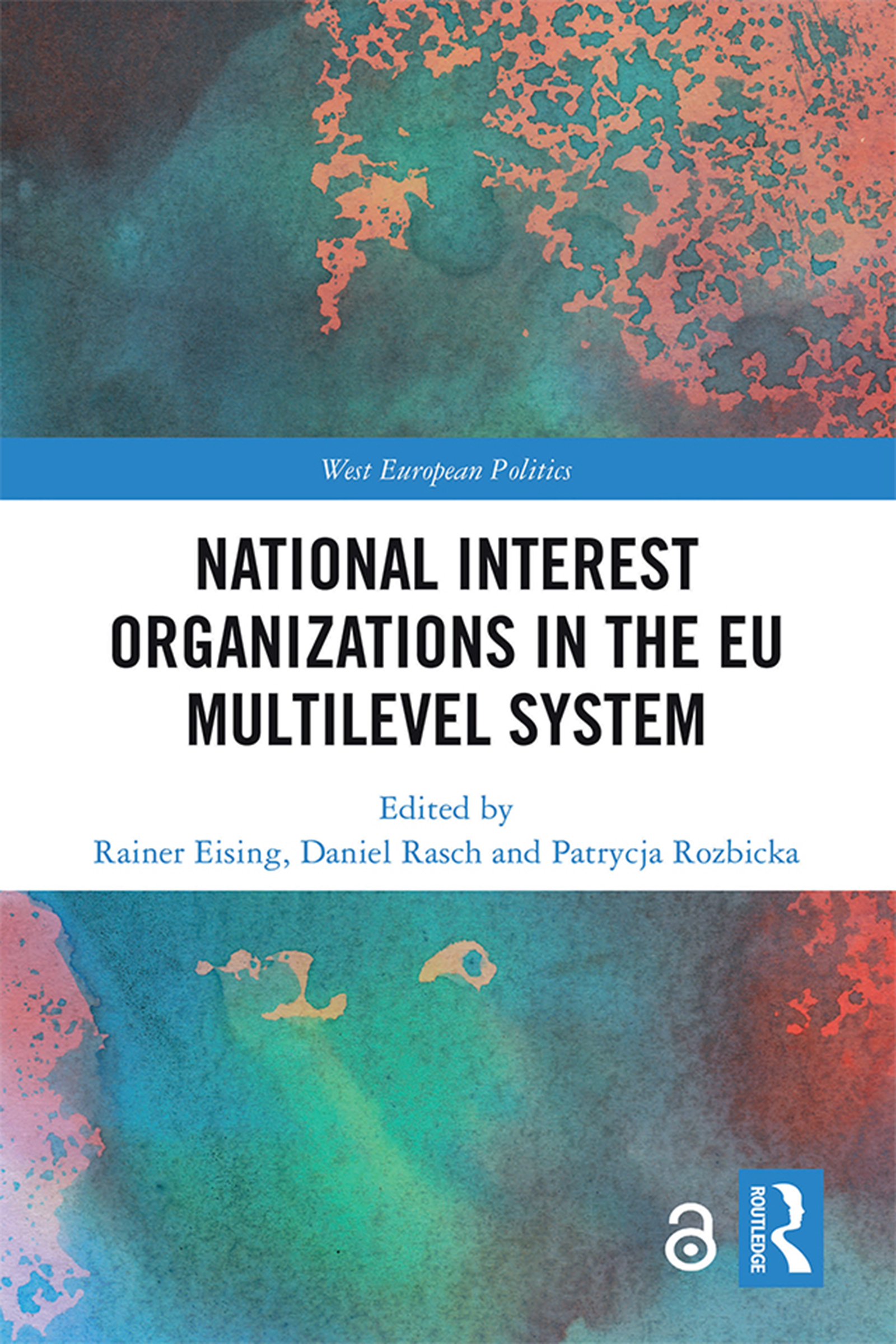
National Interest Organizations in the EU Multilevel System Political scientists have always accorded interest organizations a prominent place in European Union (EU) policy-making because they connect the EU institutions to citizens, provide important information to EU policy-makers, and control resources that impact on the problem-solving capacity of EU policies. In other words, they are vital to both the input legitimacy and the output legitimacy of the EU. So far, research on interest organizations in EU policy-making has concentrated on EU-level interest organizations and EU-level politics. This edited book draws attention to the role national interest organizations play in the EU multilevel system. All contributions present state-of-the-art research on that subject in the form of theory-driven empirical analyses. Chapter 8 of this book is freely available as a downloadable Open Access PDF under a Creative Commons Attribution-Non Commercial-No Derivatives 3.0 license. https://s3-us-west-2.amazonaws.com/tandfbis/rt-files/docs/Open+Access+Chapters/9781138614741_oachapter8.pdf POLITICAL SCIENCE,General
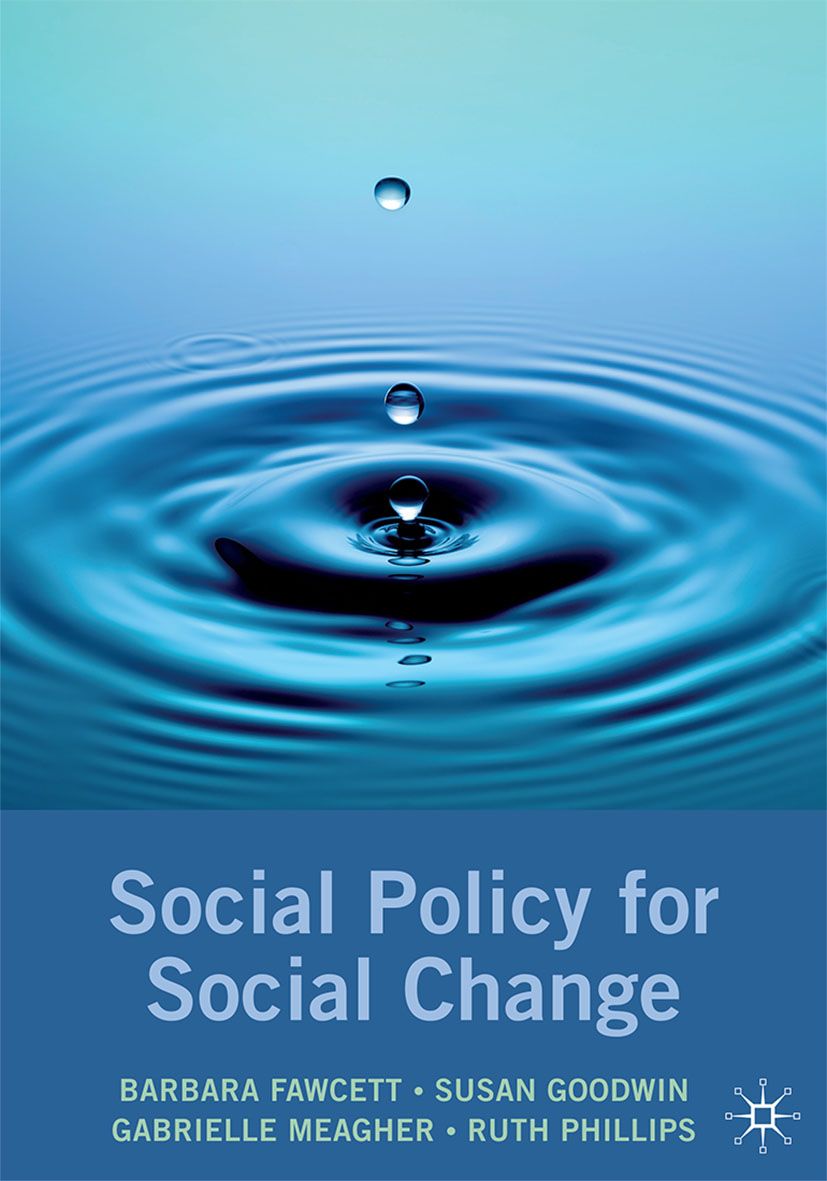
Social Policy for Social Change Social policy can be a powerful vehicle for positive social change. This book explores how social policy is made and by whom, focusing on debates about what counts as a social problem, and on conflicts over ideals, power and resources in the framing of policy solutions. Social policy is shown to be dynamic, flexible and provisional, and the opportunities for human service practitioners to engage in the processes of making and implementing social policy for social change are emphasised. POLITICAL SCIENCE,General

European Societies Today This accessible new text introduces students to contemporary European societies by examining structures of inequality, making sense of the empirical and historical contexts. Focusing on seven differing European societies (France, Germany, Ireland, Italy, Poland, Sweden and the UK), it examines the different ways in which sociology and political economy understand the social structure of contemporary Europe. Separate chapters outline key aspects of inequality, beginning with income, wealth and poverty, followed by occupation and social class, gender, regional inequality, ethnicity, and migration. By focusing on the role of the national welfare states of Europe in restraining economic inequality, the book enables a realistic appraisal of the ‘European Social Model’. Key features: Examines European ‘distinctiveness’ and difference; Visual presentation of data accessibly informs the reader about distinctive features of specific societies; Comparative approach extends to evaluate the extent to which Europe differs from the USA; Illustrates how the UK’s half-hearted relationship to ‘Europe’ is not just a matter of history or politics but also of contemporary social structure; Key in-text features include discussion topics and key readings. This textbook will be essential reading for students of European studies, European politics, European societies, social inequality/structure, European welfare and policy and more broadly to sociology and public policy and administration. POLITICAL SCIENCE,General
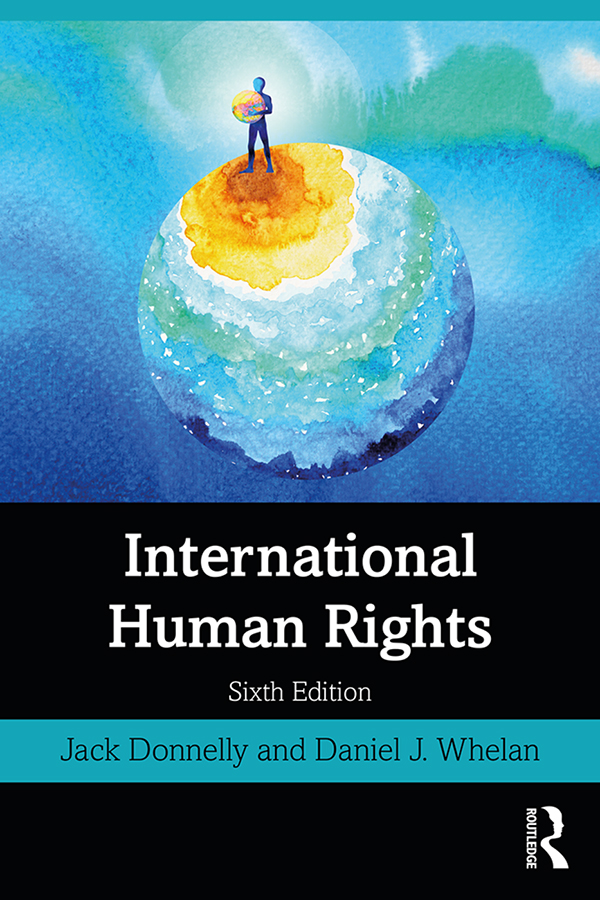
International Human Rights Fully updated, the sixth edition of International Human Rights examines the ways in which states and other international actors have addressed human rights since the end of World War II. This unique textbook features substantial attention to theory, history, international and regional institutions, and the role of transnational actors in the protection and promotion of human rights. Its purpose is to explore the difficult and contentious politics of human rights, and how those political dimensions have been addressed at the national, regional, and especially international levels. Key features include: substantially revised throughout, including new material on LGBTQ rights in Africa, Indigenous peoples’ rights in Guatemala, the Rohingya crisis in Myanmar, and a new chapter on human rights and development; in-text features such as discussion questions, suggested readings, case studies, and "problems" to promote classroom discussion and in-depth examination of topics; concise yet clearly organised and comprehensive coverage of the topic. International Human Rights is essential reading for courses and modules in human rights, politics and international relations, law, criminal justice, sociology, social work, public administration, and international development. POLITICAL SCIENCE,General
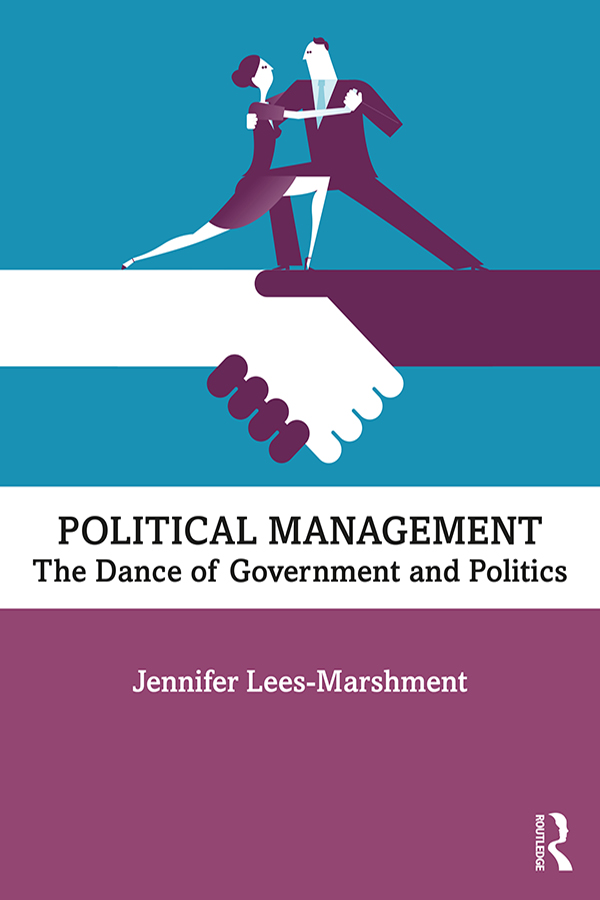
Political Management Political Management lays out the core tools to manage government, campaigns and parties. The first book to combine management concepts with politics and government, it provides core theories for what Political Planning, Political HR, Political Organising, Political Leadership and Political Reviewing involve, illustrated with high level political practitioner interviews, examples and political documents. The text presents the 4 Ds of Political Management - Deliberating, Designing, Doing and Dancing - to convey that Political Management is more of a dance than a march. Even presidents and prime ministers do not have enough formal authority to control the myriad of practitioners, players, processes and policies involved in 21st century governance. In this book, the author demonstrates why political practitioners in campaign teams, parties, government departments and political offices need political management tools to utilise the resources they have available and overcome multiple obstacles that practical politics presents. By offering a clear sense of what political management involves and providing the theoretical frameworks to be used in empirical research, this book will stimulate significant future study. It will be invaluable to practitioners, scholars and students in politics, government, policy, leadership, management, public administration, and political management. POLITICAL SCIENCE,General
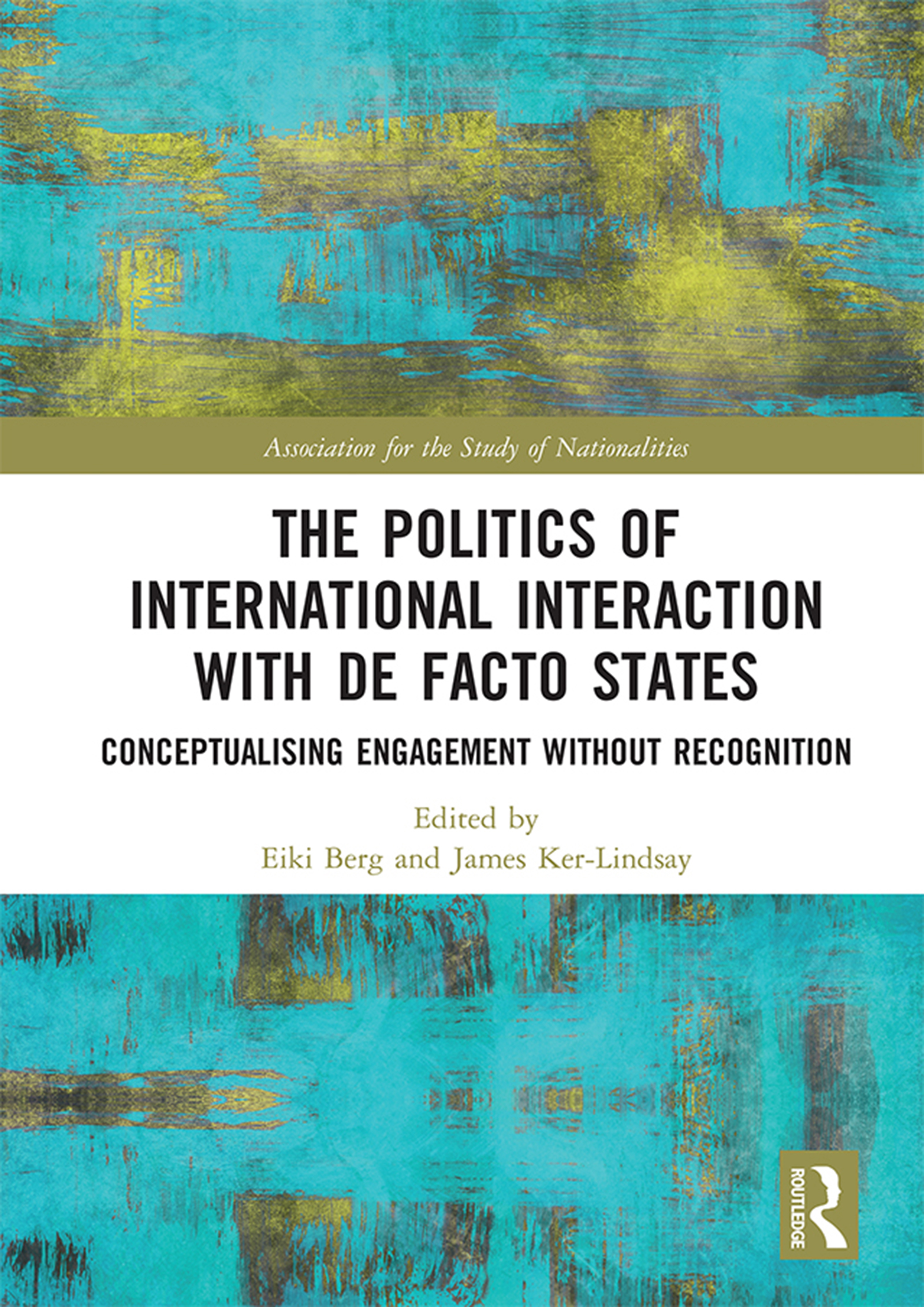
The Politics of International Interaction with de facto States This comprehensive volume is the first systematic effort to explore the ways in which recognised states and international organisations interact with secessionist ‘de facto states’, while maintaining the position that they are not regarded as independent sovereign actors in the international system. It is generally accepted by policy makers and scholars that some interaction with de facto states is vital, if only to promote a resolution of the underlying conflict that led to their decision to break away, and yet this policy of ‘engagement without recognition’ is not without complications and controversy. This book analyses the range of issues and problems that such interaction inevitably raises. The authors highlight fundamental questions of sovereignty, conflict management and resolution, settlement processes, foreign policy and statehood. This book will be of interest to policy makers, students and researchers of international relations. It was originally published as a special issue of the journal Ethnopolitics. POLITICAL SCIENCE,General
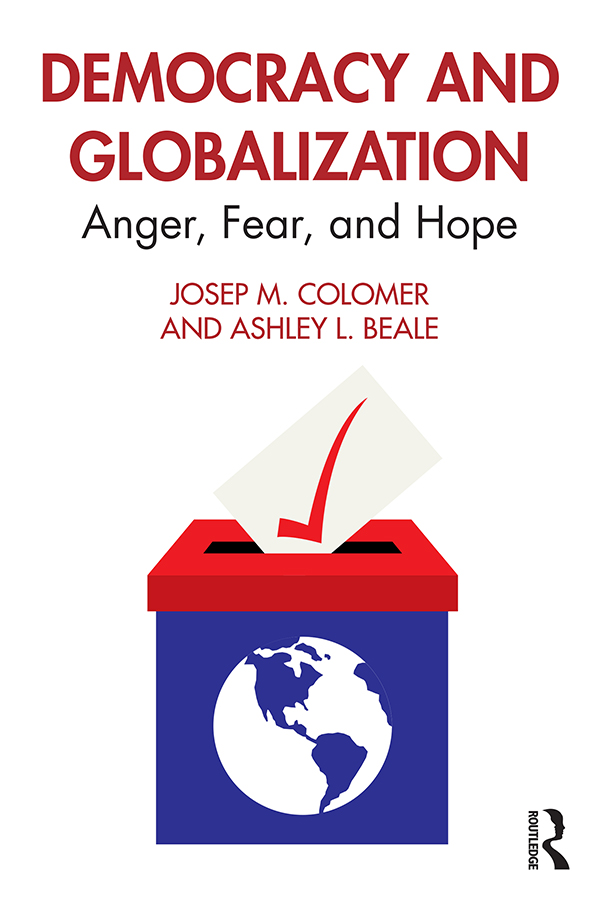
Democracy and Globalization As democracy is disrupted by globalization, the solution is to globalize democracy. This book explores the causes of the current crisis of democracy and advocates new ways for more representative, effective, and accountable governance in an interdependent world. Part 1 analyzes the split of the middle class and the subsequent political polarization which underlies people’s dissatisfaction with the way democracy works in developed countries. It also addresses the role of political emotions, including disappointments about unmet expectations, anger incited from opposition candidates, fear induced from government, and hope wrapping up new proposals for reform and change. In Part 2, the authors argue that a more effective governance would require reallocations of power at local, national, continental and global levels with innovative combinations of direct democracy, representative government, and rule by experts. This book will be of interest to students and scholars of political science, comparative politics, international relations, political economy and democratic theory, as well as general readers interested in politics and current events. POLITICAL SCIENCE,General
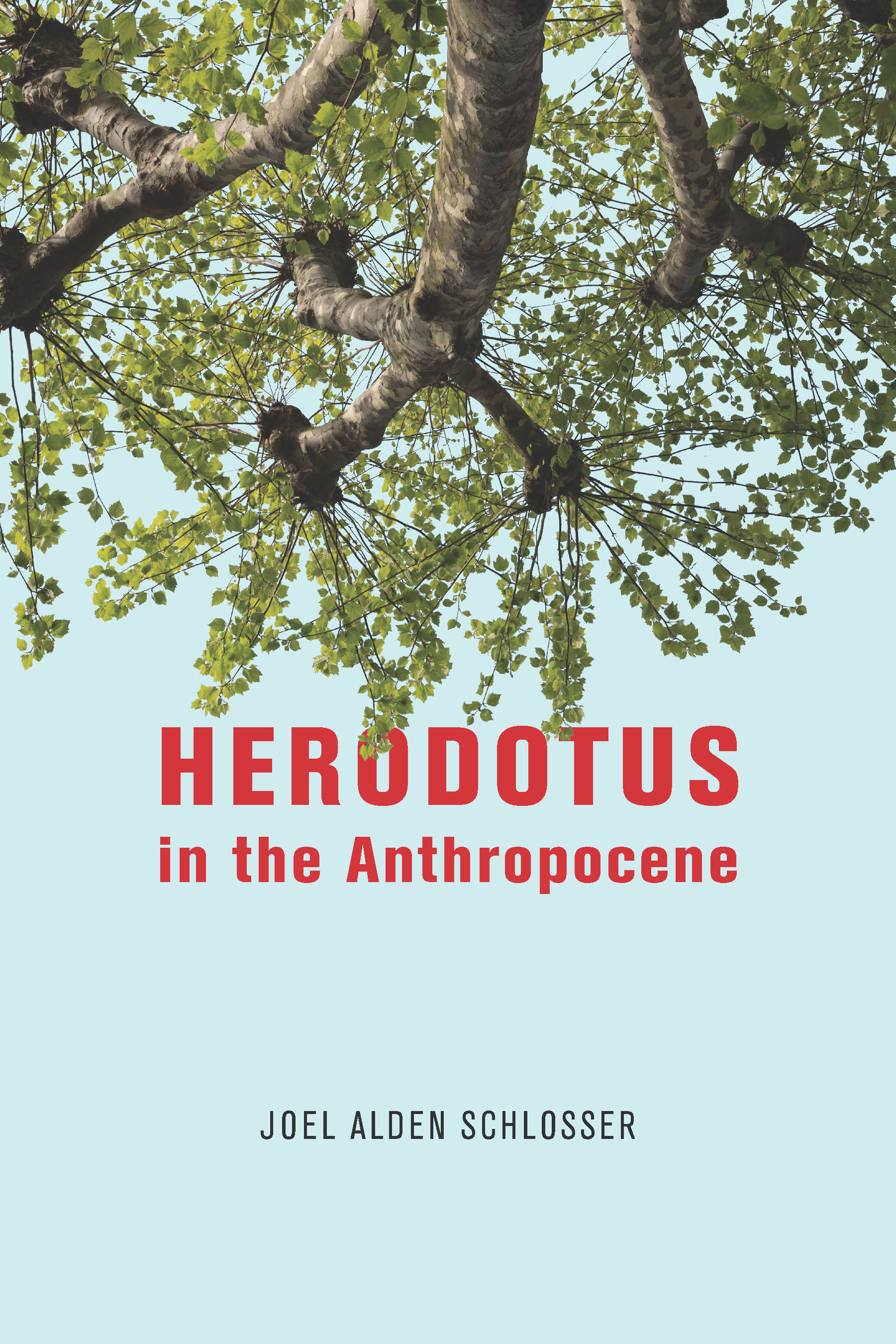
Herodotus in the Anthropocene We are living in the age of the Anthropocene, in which human activities are recognized for effecting potentially catastrophic environmental change. In this book, Joel Alden Schlosser argues that our current state of affairs calls for a creative political response, and he finds inspiration in an unexpected source: the ancient writings of the Greek historian Herodotus. Focusing on the Histories, written in the fifth century BCE, Schlosser identifies a cluster of concepts that allow us to better grasp the dynamic complexity of a world in flux. Schlosser shows that the Histories, which chronicle the interactions among the Greek city-states and their neighbors that culminated in the Persian Wars, illuminate a telling paradox: at those times when humans appear capable of exerting more influence than ever before, they must also assert collective agency to avoid their own downfall. Here, success depends on nomoi, or the culture, customs, and laws that organize human communities and make them adaptable through cooperation. Nomoi arise through sustained contact between humans and their surroundings and function best when practiced willingly and with the support of strong commitments to the equality of all participants. Thus, nomoi are the very substance of political agency and, ultimately, the key to freedom and ecological survival because they guide communities to work together to respond to challenges. An ingenious contribution to political theory, political philosophy, and ecology, Herodotus in the Anthropocene reminds us that the best perspective on the present can often be gained through the lens of the past. POLITICAL SCIENCE,General

Political Representation in Southern Europe and Latin America This collective volume - with contributions from experts on these regions - examines broader questions about the current crises (The Great Recession and The Commodity Crisis) and the associated changes in political representation in both regions. It provides a general overview of political representation studies in Southern Europe and Latin America and builds bridges between the two traditions of political representation studies, affording greater understanding of developments in each region and promote future research collaboration between Southern Europe and Latin America. Finally, the book addresses questions of continuity and change in patterns of political representation after the onset of the two economic crises, specifically examining issues such as changes in citizens’ democratic support and trust in political representatives and institutions, in-descriptive representation (in the sociodemographic profile of MPs) and in-substantive representation (in the link between voters and MPs in terms of ideological congruence and/or policy/issue orientations). This book will be of key interest to scholars and students of political elites, political representation, European and Latin American politics/studies, and more broadly to comparative politics. POLITICAL SCIENCE,General
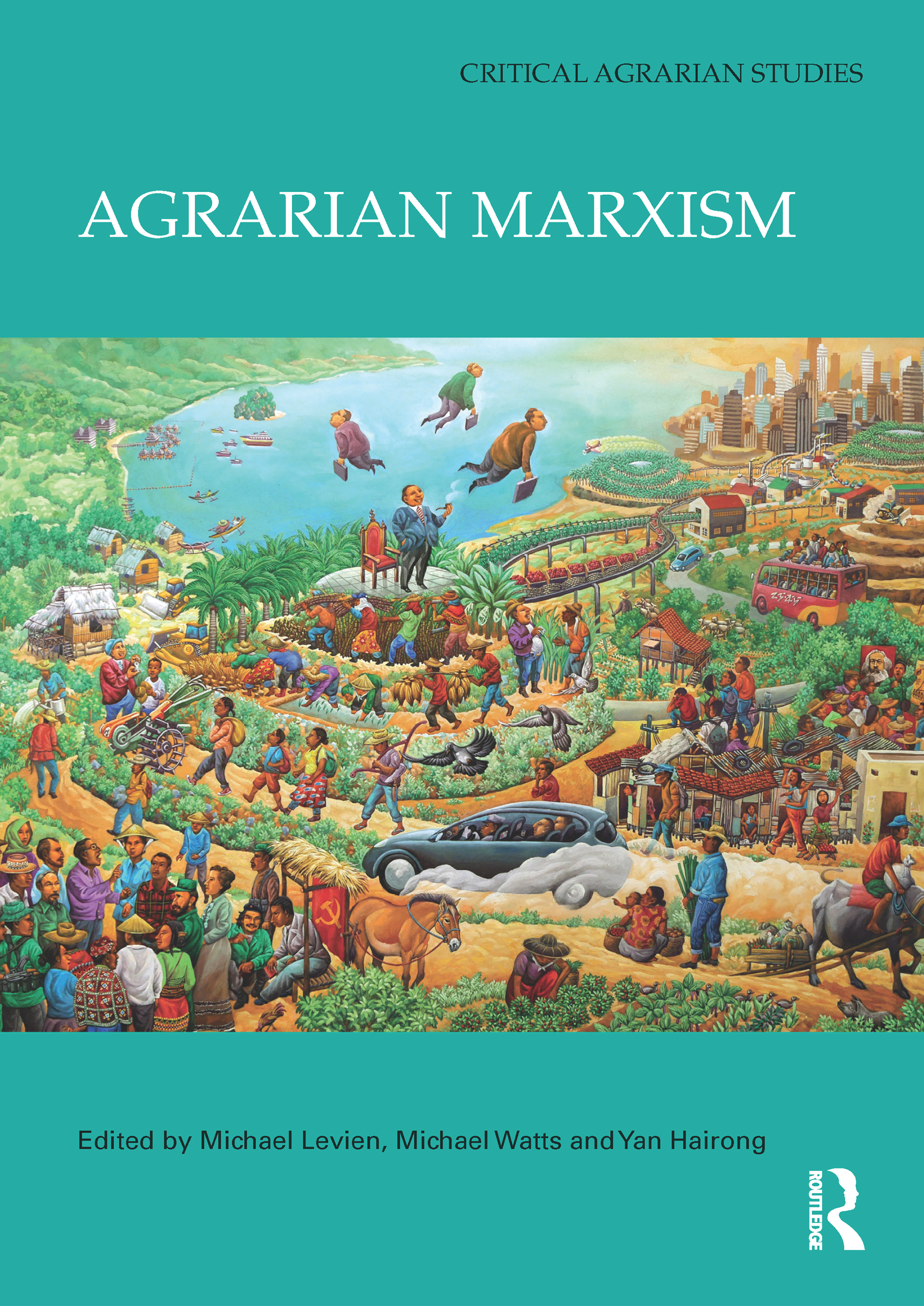
Agrarian Marxism This comprehensive volume advances heterodox reconstructions of agrarian Marxism on the occasion of Marx’s 200th birth anniversary. While Marxists have long criticized ‘populists’ for ignoring capitalism and class, populists have charged Marxists with historical determinism. This ongoing debate has now reached something of an impasse, in part because new empirical work addressing the complex contemporary patterns and conjunctures of global agrarian capitalism offers exciting new horizons, along with new and generative theoretical reconstructions of Marxism itself. This book helps to point the way beyond this impasse, and illustrates that agrarian Marxism remains a dynamic theoretical program that offers powerful insights into agrarian change and politics in the twenty-first century. This book was originally published as a special issue of The Journal of Peasant Studies. POLITICAL SCIENCE,General

Collective Securitisation and Security Governance in the European Union Collective Securitisation and Security Governance in the European Union presents an integrated theory of collective securitisation – a theoretical foundation for explaining how the process of collective securitisation sustains and makes effective an identifiable system of regional security governance. The volume demonstrates the empirical utility of collective securitisation in the EU security space through a set of structured case studies focusing on the collective securitisation of terrorism, cyberspace, migration, energy, health and climate change. The contributions to this collection address three questions: Under what conditions does collective securitisation occur? How does collective securitisation affect the scope and domains of EU security governance? And how does collective securitisation explain the emergence of the EU system of security governance? This volume breaks new ground in the field of EU security studies and provides a theoretical orientation that contributes to our understanding of how and why the EU has developed as a security actor in the 21st century. Developing and testing the theory of collective securitisation with reference to some of the most pressing contemporary security issues, Collective Securitisation and Security Governance in the European Union will be of great interest to scholars of the European Union and Security Studies. The chapters were originally published as a special issue of West European Politics. POLITICAL SCIENCE,General

Rising Powers in International Conflict Management Rising Powers in International Conflict Management locates rising powers in the international conflict management tableau and decrypts their main motives and limitations in the enactment of their peacebuilding role. The book sheds light on commonalities and divergences in a selected group of rising powers’ (namely Brazil, India, China, and Turkey) understanding and applications of conflict management and explains the priorities in their conflict management strategies from conceptual/theoretical and empirical aspects. The case studies point to the evolving nature of conflict management policies of rising powers as a result of their changing priorities in foreign and security policy and the shifts observed in the international order since the end of the Cold War. The country-specific perspectives provided in this study have also proven right the potentialities of rising powers in managing conflicts, as well as their past and ongoing challenges in envisaging crises in both their own regions and extra-regional territories. Improving the understanding of the strengths and weaknesses of rising powers as conflict management actors and peacebuilders at regional and international levels, Rising Powers in International Conflict Management will be of great interest to scholars of international relations, conflict studies, and peacebuilding. The chapters were originally published as a special issue of Third World Quarterly. POLITICAL SCIENCE,General
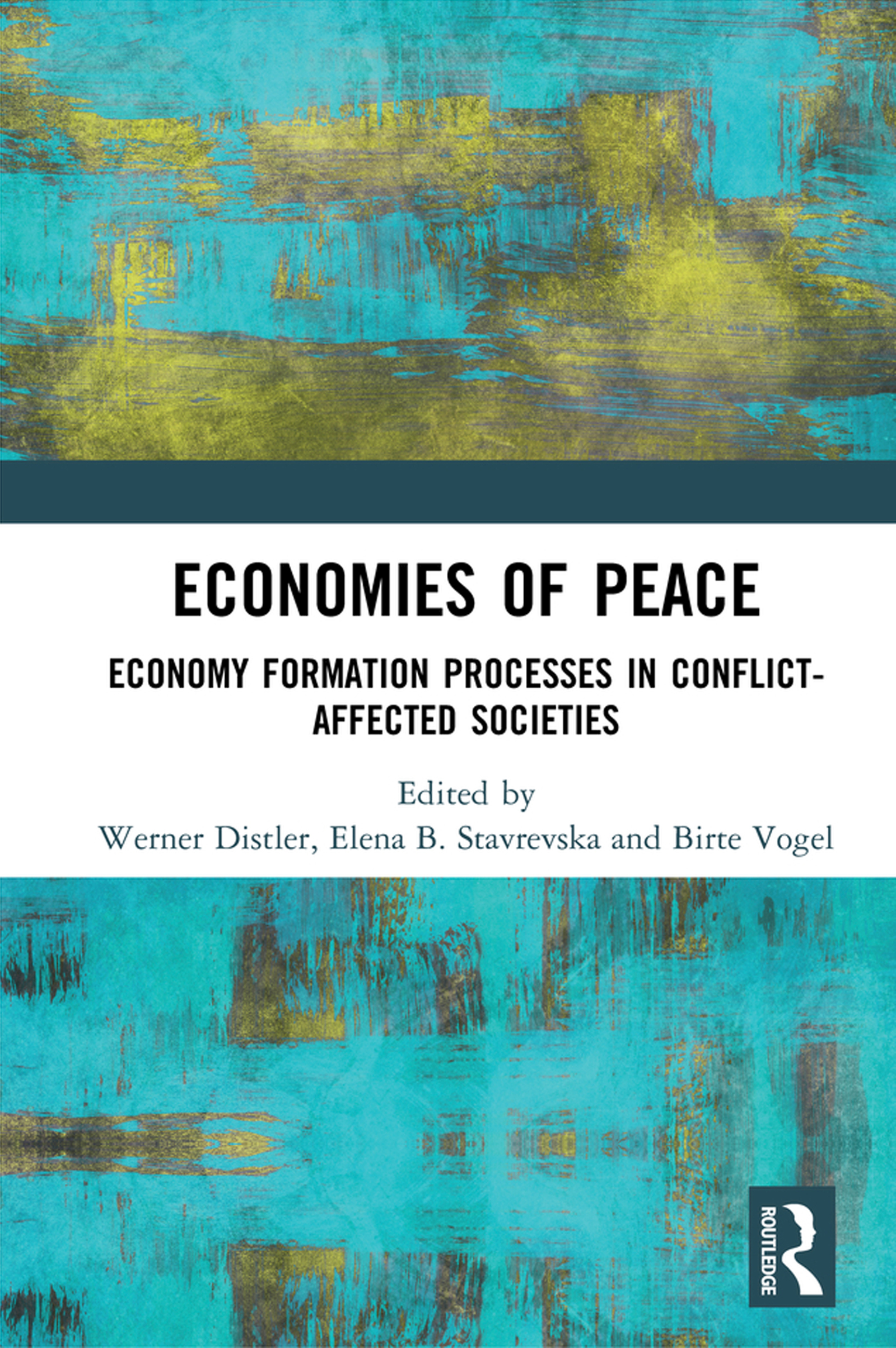
Economies of Peace Looking beyond and beneath the macro level, this book examines the processes and outcomes of the interaction of economic reforms and socio-economic peacebuilding programmes with, and international interventions in, people’s lived realities in conflict-affected societies. The contributions argue that disregarding socio-economic aspects of peace and how they relate to the everyday leaves a vacuum in the understanding of the formation of post-conflict economies. To address this gap, the book outlines and deploys the concept of ‘post-conflict economy formation’. This is a multifaceted phenomenon, including both formal and informal processes that occur in the post-conflict period and contribute to the introduction, adjustment, or abolition of economic practices, institutions, and rules that inform the transformation of the socio-economic fabric of the society. The contributions engage with existing statebuilding and peacebuilding debates, while bringing in critical political economy perspectives. Specifically, they analyse processes of post-conflict economy formation and the navigation between livelihood needs; local translations of the liberal hegemonic order; and different, sparse manifestations of welfare states. The book concludes that a sustainable peace requires the formation of peace economies: economies that work towards reducing structural inequalities and grievances of the (pre-)conflict period, as well as addressing the livelihood concerns of citizens. This book was originally published as a special issue of Civil Wars. POLITICAL SCIENCE,General

When States Take Rights Back When States Take Rights Back draws on contributions by international experts in history, law, political science, and sociology, offering a rare interdisciplinary and comparative examination of citizenship revocation in five countries, revealing hidden government rationales and unintended consequences. Once considered outdated, citizenship revocation – also called deprivation or denationalization – has come back to the political center in many Western liberal states. Contributors scrutinize the positions of stakeholders (e.g. civil servants, representatives of civil society, judges, supranational institutions) and their diverse rationales for citizenship revocation (e.g. allegations of terrorism, treason, espionage, criminal behaviour, and fraud in the naturalisation process). The volume also uncovers the variety of tools that national governments have at their disposition to change existing citizenship revocation laws and policies, and the constraints that they are faced with to actually implement citizenship revocation in daily operations. Finally, contributors underscore the extraordinary severity of sanctions implied by citizenship revocation and offer a nuanced picture of the material and symbolic forms of exclusion not only for those whose citizenship is withdrawn but also for minority groups (wrongly) associated with the aforementioned allegations. Indeed, revocation policies target not merely individuals but specific collective categories, which tend to be ethno-racially constructed and attributed specific location within the international status hierarchy of nation-states. International and interdisciplinary in scope, When States Take Rights Back will be of great interest to scholars of politics, international law, sociology and political and legal history, and Human Rights. The chapters were originally published in Citizenship Studies. POLITICAL SCIENCE,General
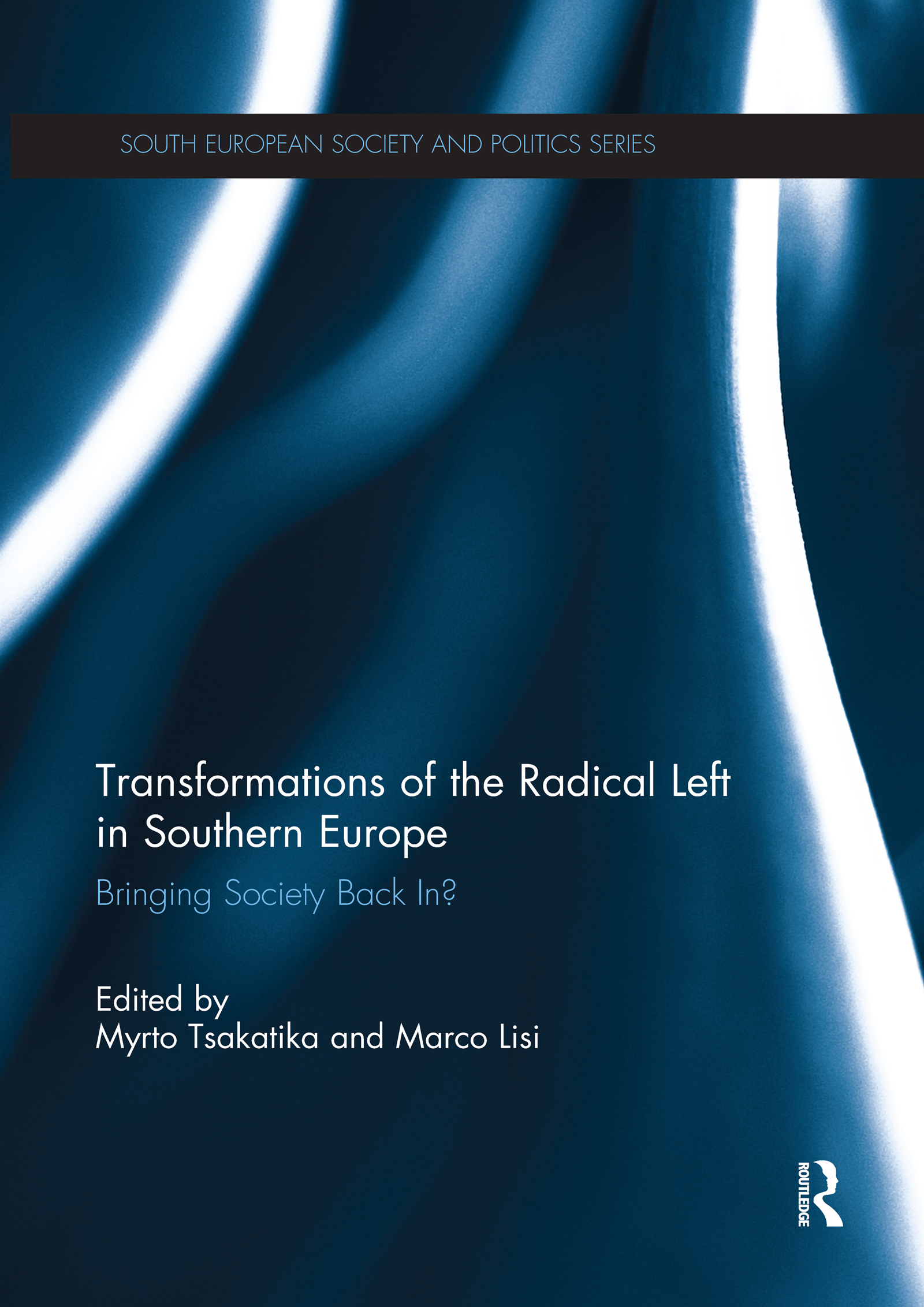
Transformations of the Radical Left in Southern Europe Political parties are alleged to be turning their backs to civil society; they are said to discourage the active participation of their members and to distance themselves from the privileged relations to affiliated social organisations they once prized. Instead, parties are broadly believed to be directing their efforts towards capturing government office and the resources that come with it, neglecting linkage to their social roots. Transformations of the Radical Left in Southern Europe questions this widely shared view. Exploring the social linkage strategies of the most relevant radical left parties in Portugal, Spain, Italy, Greece and Cyprus in depth, this book demonstrates that the members of the European radical left party family continue to prioritise social linkage, despite their increasingly office-seeking orientation. Between the fall of the Berlin Wall in 1989 and the current economic crisis they have been tirelessly experimenting with diverse new forms of party organisation that have enabled them to return to their social roots. The main lesson drawn from the studies in this book is that party ideology and a party’s position in the national political arena go a long way towards explaining the extent to which political parties prioritise social linkage. This book was published as a special issue of South European Society and Politics. POLITICAL SCIENCE,General
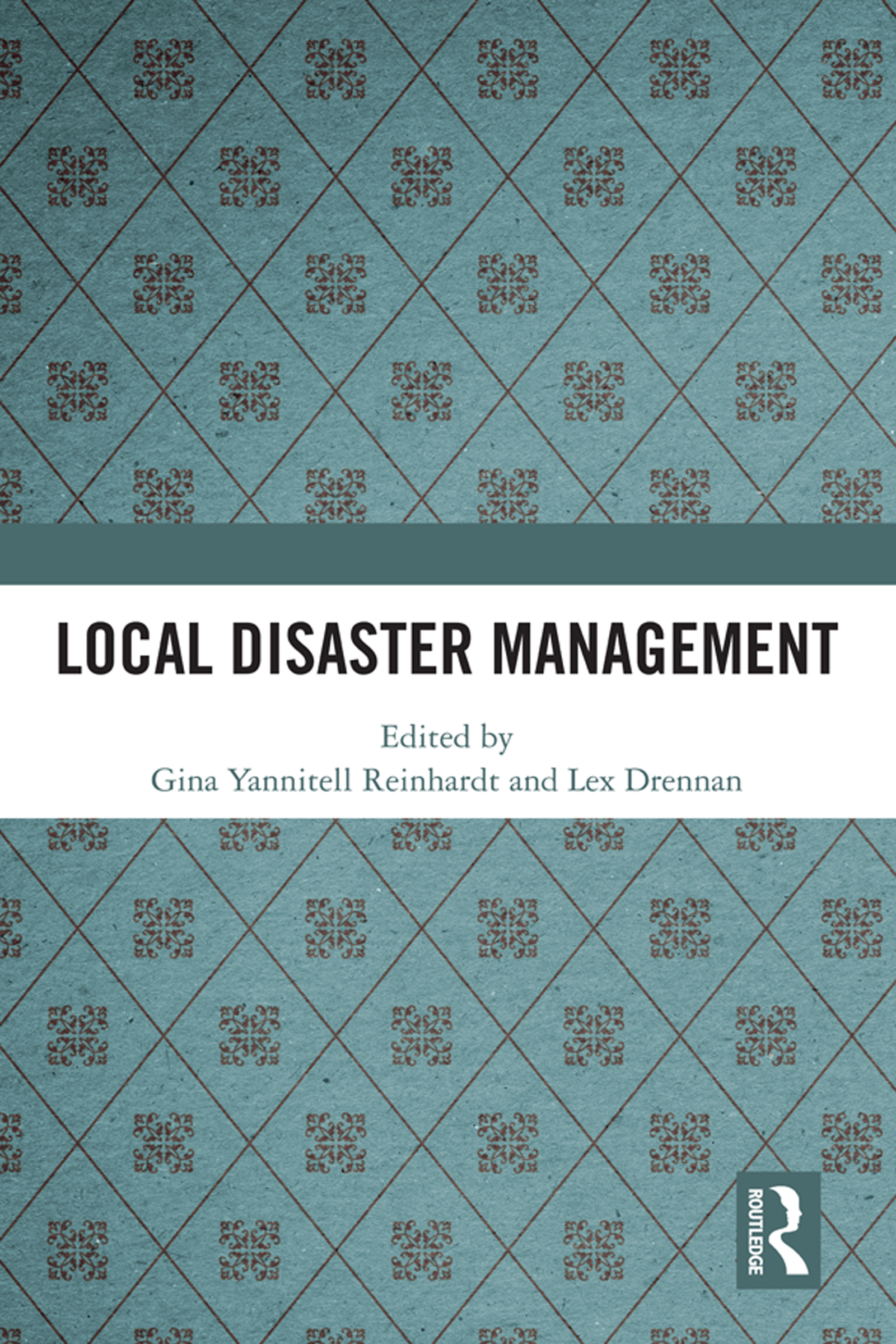
Local Disaster Management Local Disaster Management explores what resilience means for local communities and local governments on the front line of responding to disasters and emergencies. Disaster management is often seen as a major international issue undertaken by global actors such as the UN, Red Cross and Red Crescent. Yet fundamentally, all disasters are local. Every disaster, regardless of its type, affects individuals, families and communities before they escalate to encompassing one or many communities or nations. This volume therefore explores fundamental issues of disaster and emergency management at the local level. What is resilience? What does resilience mean for a local government seeking to lessen the impact of disasters on their community? How do local governments adapt through their experiences of disasters and how do they recover from catastrophic experiences? This book explores these issues with chapters from top scholars in the field, draws out lessons for local government officials and disaster managers seeking to build community resilience, prepare their communities for a changing environment, and facilitate recovery after disasters strike. Local Disaster Management provides invaluable insight for local governments charged with managing the inescapable effects of climate change and the increasing frequency and severity of disasters, as well as for scholars of local governance, disaster resilience, government policy, and disaster management. The chapters were originally published as a special issue in Local Government Studies. POLITICAL SCIENCE,General
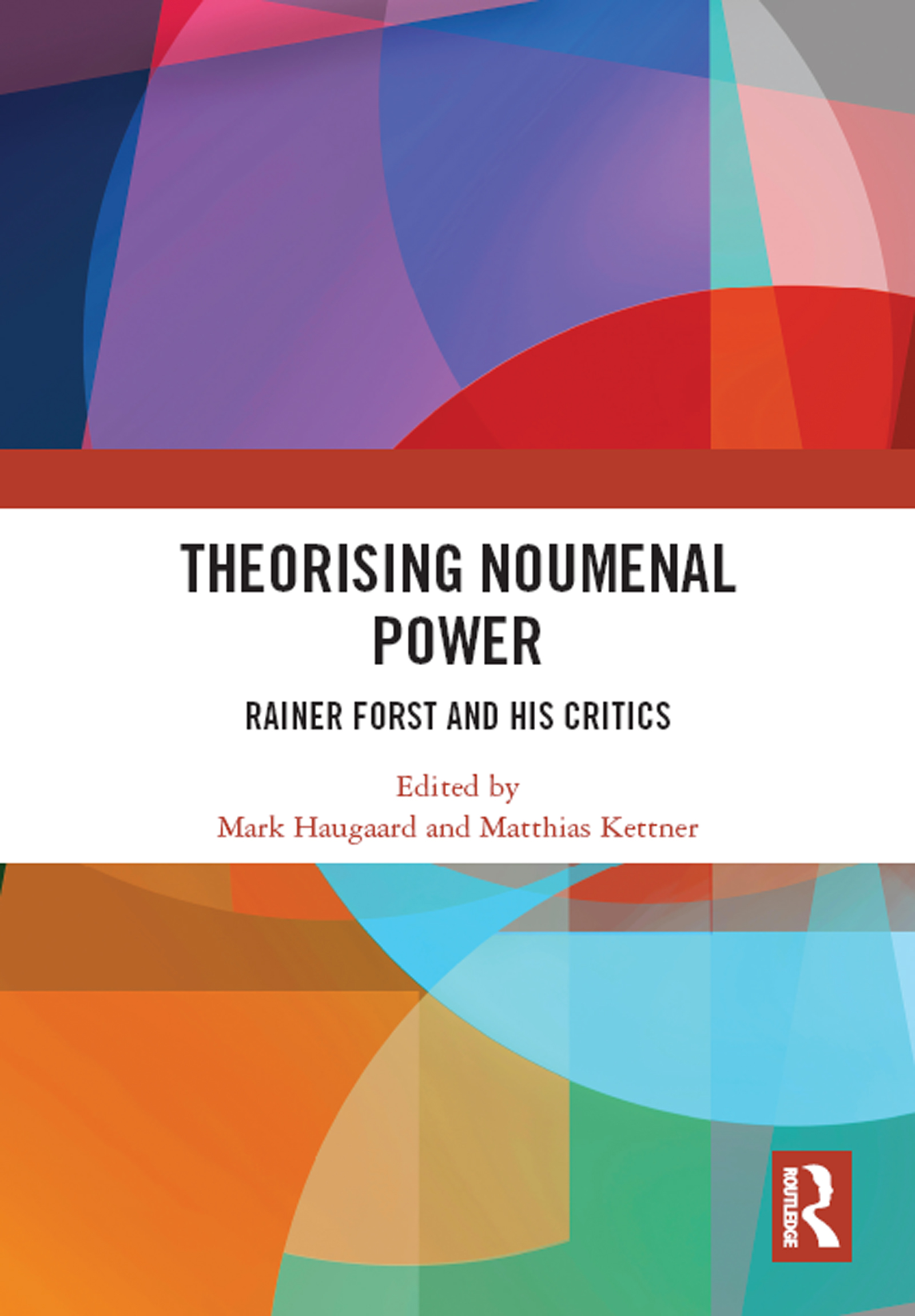
Theorising Noumenal Power Theorising Noumenal Power is a critical engagement with Rainer Forst’s theory of what he calls "noumenal power." Forst is the most significant younger generation critical theorist of the Frankfurt School, and his critics include several of the most influential contemporary political power theorists. The concept of noumenal power locates the sources of social and political power in the space of reasons or justifications – using a normatively neutral account of "justification." To exercise power, on that account, means to be able to determine, use, close or open up the space of justifications for others. Going back to Kant, the social subject is theorized as a reasoning being who confers legitimacy upon political structures based upon the cognitive faculty of justification. As argued by Max Weber, authority is the foundation of political institutions and authority presupposes a belief in legitimacy. On the one hand such beliefs can be distorted, as in ideology, or they can be based upon a process of reasoned justification relative to normatively desirable principles. Critiquing the former, while building upon the latter, serves as the foundation for theorising just democratic politic institutions. For Forst’s critics, a key theme is how to differentiate ideological (bad) justification, typically based upon emotion, from normatively right democratic reasoning. Other important themes are the analysis of structural domination or the use of threats or other means of exercising power. The debate in this volume constitutes an exciting new way of re-thinking the foundations of ideology, political power, democracy and justice. Providing a state-of-the-art discussion concerning the relationship between political power and justification Theorising Noumenal Power is essential for students and scholars interested in the theoretical foundations of political power, democracy and justice. The chapters were originally published in the Journal of Political Power. POLITICAL SCIENCE,General
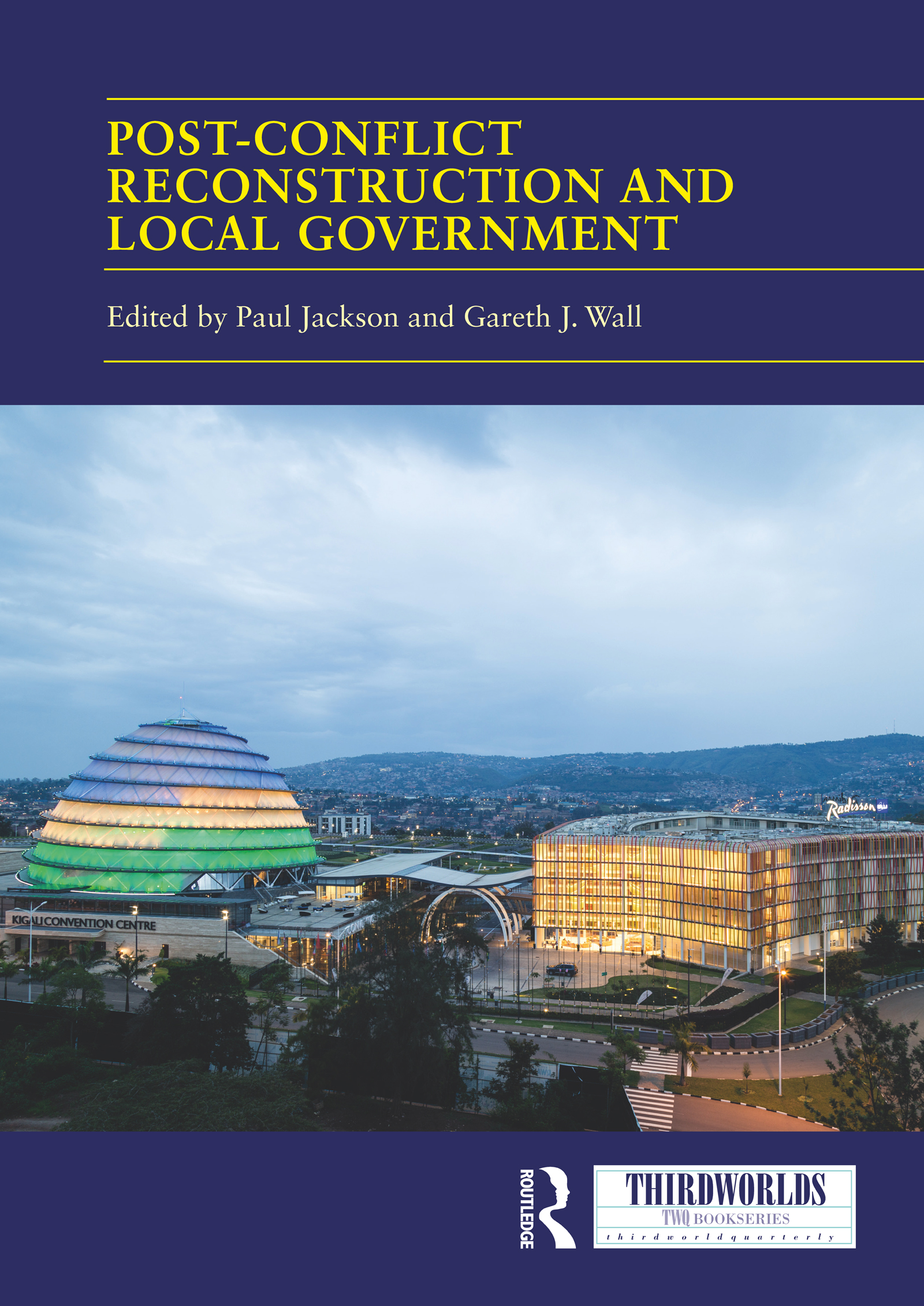
Post-conflict Reconstruction and Local Government The subject of local government and post-conflict reconstruction sits at the intersection of several interrelated research areas, notably conflict/peacebuilding, governance, and political economy. This volume addresses a gap in the academic literature: whilst decentralisation is frequently included in peace agreements, the actual scope and role of local government is far less frequently discussed. This gap remains despite a considerable literature on local government in developing countries more generally, particularly with regard to decentralisation; but also, despite a considerable and growing literature on post-conflict reconstruction. This volume provides a mixture of case study, cross-case studies, practitioner reflection, and conceptual material on the function of local government in the context of decentralisation in post-conflict countries, from both academics and policy-makers. This collection of in-depth single- and multi-country case study analysis is complemented by practitioner reflections and framed within the 2030 Agenda building on the New Urban Agenda, and particularly the Sustainable Development Goal 16 to ‘promote peaceful and inclusive societies for sustainable development, provide access to justice for all and build effective, accountable and inclusive institutions at all levels.’ The chapters in this book were originally published in the online journal Third World Thematics. POLITICAL SCIENCE,General

Violence and the Third World in International Relations Violence and the Third World in International Relations is intended as a contribution to the decolonization of international relations, and especially of international security studies, much of which is dominated by a self-sustaining Eurocentrism. Rather than focusing on the motivations of violence, this volume is concerned with the devastating and debilitating consequences of war against the Third World. Contributors delve into the violent structuring of Third World societies during colonialism, the Cold War, and globalization. A wide range of topics are systematically examined, including, but not restricted to, the role of racism in the construction of the international system; evangelical universalism and colonial conquest in Africa; American civilizational security as Grand Strategy in Asia; the colonial roots of guerrilla war in India; the widespread suffering and death inflicted on Iraqis through sanctions; violence against indigenous peoples in Colombia related to ‘war capitalism’; the complicated legacies of genocide in Cambodia; the Saudi-led, (US and UK backed) war against Yemen; the relationalities between violence in the US and the Third World during Obama’s presidency; the structural location of gang violence in Central America in the aftermath of foreign intervention; and a broader understanding of security and insecurity in the Caribbean. Violence and the Third World in International Relations will be of particular interest to scholars of postcolonial and decolonial international relations, international security studies, and race and international relations. This book was originally published as a special issue of Third World Quarterly. POLITICAL SCIENCE,General
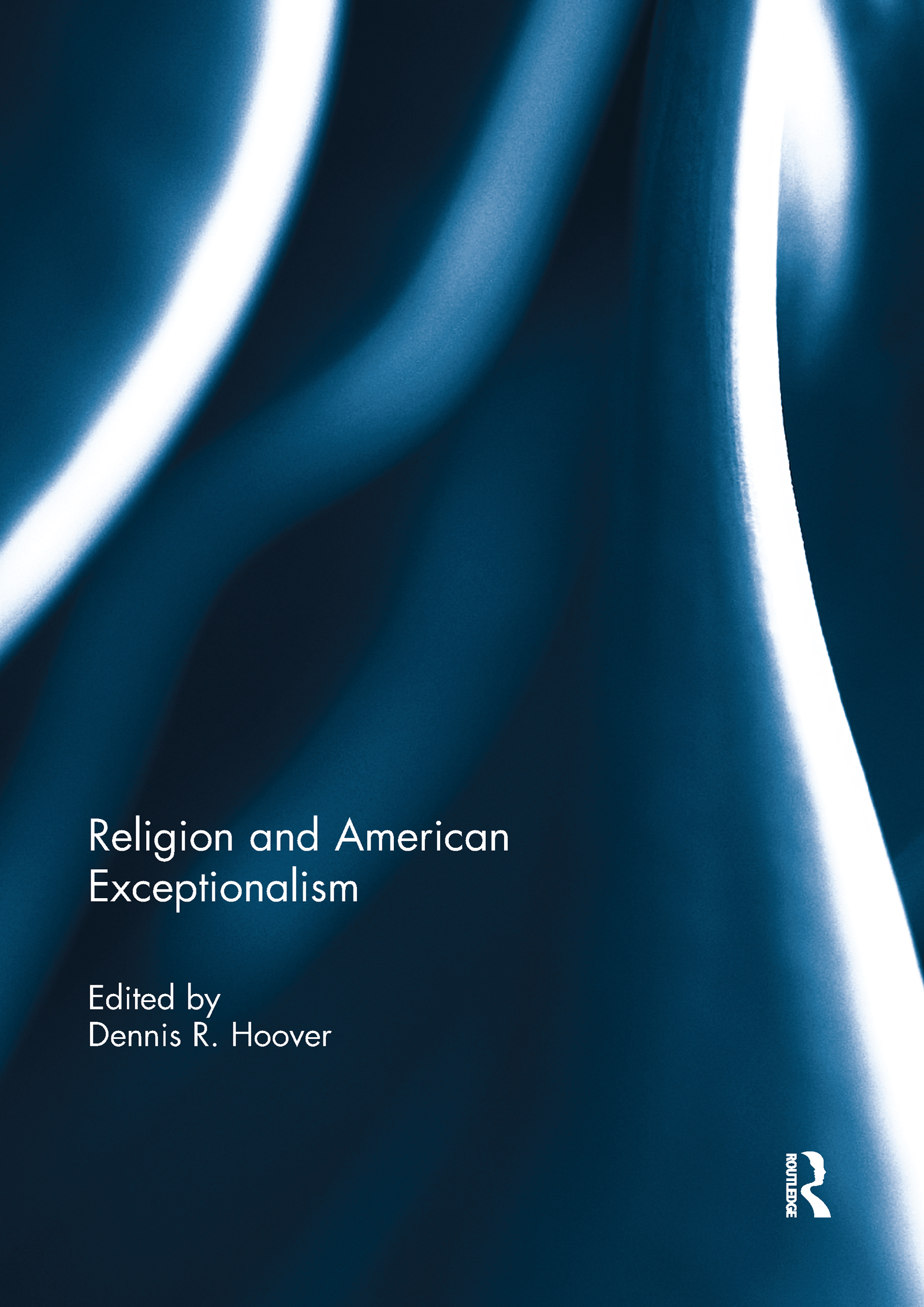
Religion and American Exceptionalism "American exceptionalism" was once a rather obscure and academic concept, but in the 2012 presidential election campaign the phrase attained unprecedented significance in political rhetoric. President Obama’s conservative critics—most notably Sarah Palin, Newt Gingrich, and Mitt Romney—accused the president of disbelieving in American exceptionalism and thereby offending the nation’s civil religion. This creed traditionally has included the notion that America is a political "new Israel" called by God and guided by His Providence to be the exemplar, vanguard, and champion of liberal democracy and the free market for all humanity. The newly politicized narrative of exceptionalism portrayed Obama as a president embarrassed by his own country and intent on remaking the United States in the image of the secularist and socialist countries of Europe. This book takes a step back from the partisan rhetorical bluster and examines afresh the historical and analytical meanings of American exceptionalism, and the extent to which religion—both "real" religion and the more ambiguous "civil" religion—has shaped these meanings and their uses/abuses. This book was published as a special issue of The Review of Faith and International Affairs. POLITICAL SCIENCE,General

Transnational Food Security Transnational Food Security addresses food security from an international relations, political economy and legal perspective analysing the relationship between food security and the environment and climate change, trade, finance and contracts, and the intersection between food and human rights. The topic of food concerns one of the most basic and profound aspects of human survival. Universal and equal access to food is, at the same time, ridden with problems of power, inequality, distribution and implicated in old and new geopolitical conflicts. As such, ‘food’ and food security are central to conditions of poverty and hunger, development and ‘modernisation’, transitional justice and rule of law reform around the world. As a problem of critique and scholarly inquiry, food prompts an inter-disciplinary assessment of the nature of food security in the modern world. The contributors to this book take us deep into the complexity of food and illustrate the challenges of adequately understanding and approaching questions of food security and food sovereignty in a globally interconnected world. Transnational Food Security will be of great interest to scholars of international relations, political economy, and transnational law. The chapters were originally published as a special issue of Transnational Legal Theory Journal. POLITICAL SCIENCE,General

The European Parliament in the Contested Union The European Parliament in the Contested Union provides a systematic assessment of the real influence of the European Parliament (EP) in policy-making. Ten years after the coming into force of the Treaty of Lisbon, which significantly empowered Europe’s only directly elected institution, the contributions collected in this volume analyse whether, and under what conditions, the EP has been able to use its new powers and shape decisions. Going beyond formal or normative descriptions of the EP’s powers, this book provides an up-to-date and timely empirical assessment of the role of the EP in the European Union, focusing on key cases such as the reforms of the EU’s economic governance and asylum policy, the Brexit negotiations and the budget. The book challenges and qualifies the conventional view that the EP has become more influential after Lisbon. It shows that the influence of the EP is conditional on the salience of the negotiated policy for the Member States. When EU legislation touches upon ‘core state powers’, as well as when national financial resources are at stake, the role of the EP – notwithstanding its formal powers – is more constrained and its influence more limited. This book provides fresh light on the impact of the EP and its role in a more contested and politicised European Union. Bringing together an international team of top scholars in the field and analysing a wealth of new evidence, The European Parliament in the Contested Union challenges conventional explanations on the role of the EP, tracking down empirically its impact on key policies and processes. It will be of great interest to scholars of the European Union, European politics and policy-making. The chapters were originally published as a special issue of the Journal of European Integration. POLITICAL SCIENCE,General

Transnational Actors and Stories of European Integration This book makes a major contribution to understanding European politics and identity. It examines how politicians, cultural elites, and other actors fight over Europe’s future with words and stories, telling narratives about European integration in different political, social, and cultural contexts. The chapters explore how actors formulate stories to make sense of Europe’s past and contemporary challenges and to legitimise their own positions and preferences. The contributors explore themes ranging from divisive stories about the European Union (EU), mobilised in institutional reform referendums, to the top-down deployment of legitimising narratives by EU institutions, religiously inspired apocalyptic narratives of European unity, and stories about nations and Europe told by museums and academics. Combined, the chapters of this book are essential reading for everyone interested in Europe’s common past and contemporary challenges, and the EU’s highly contested nature in times of apparently increasing disintegration. POLITICAL SCIENCE,General

Preventing Nuclear War Preventing Nuclear War: The Medical and Humanitarian Case for the Prohibition of Nuclear Weapons provides a window into the work of the International Physicians for the Prevention of Nuclear War (IPPNW) health professionals, advocates and activists as they persuaded diplomats, parliamentarians, the media, and the public to ban nuclear weapons. Why are doctors speaking out about nuclear weapons and nuclear war, an issue that seems to be the exclusive province of diplomats, politicians, and security experts? This volume offers an answer in the unique perspective of health professionals on the nature of nuclear weapons, their medical and humanitarian consequences, and the responsibility to prevent what cannot be treated. On 7 July 2017, the UN successfully concluded negotiations on the Treaty on the Prohibition of Nuclear Weapons. The "ban treaty," emerged from a "humanitarian initiative" that shifted the focus away from deterrence-based rationales used by the nuclear-armed states and toward an evidence-based understanding of the existential threat nuclear weapons pose to humanity. Since 1980, IPPNW has been the leading medical organization primarily dedicated to the abolition of nuclear weapons. With its civil society partners in ICAN—the International Campaign to Abolish Nuclear Weapons—IPPNW brought the scientific evidence about nuclear weapons and nuclear war into the treaty negotiations and into the language of the TPNW itself. The contributors to this volume show the dedication and diverse strategies that have together made up a unified and very significant contribution to ridding the world of nuclear weapons. Reflecting honestly on what has been learnt and have the potential to contribute to wider learning outside the anti-nuclear community, Preventing Nuclear War: The Medical and Humanitarian Case for the Prohibition of Nuclear Weapons will be of great use to medical and health professionals, humanitarian professionals, and anyone wanting to work towards a more peaceful and equitable world. The chapters originally published as a special issue of Medicine, Conflict and Survival. POLITICAL SCIENCE,General

Gendering Security and Insecurity Security studies and international relations have conventionally relegated gendered analysis to the margins of academic concern, most commonly through the ‘women in’ or ‘women and’ politics and IR discourse. This comprehensive volume contributes to debates which seek to move feminist scholarship away from the reification of the war/peace and security/economy divides. By foregrounding the empirical reality of the breakdown of these traditional divisions, the authors pay particular attention to frameworks which query their very existence. In doing so, the collection as a whole troubles the ubiquitous concept and practices of ‘(in)security’ and their effects on differentially positioned subjects. By gendering (in)securities in ‘states of exception’ and other paradigms of government related to it, especially in postcolonial and neocolonial contexts, the book provides an approach that allows us to study the complex and interrelated security logics, which constitute the messy realities of different – and particularly vulnerable – subjects’ lives. In other words, it suggests that these frameworks are ripe for feminist interventions and analysis of the logics and production of (in)securities as well as of resistance and hybridisation. This book was originally published as an online special issue of the journal Third World Thematics. POLITICAL SCIENCE,General
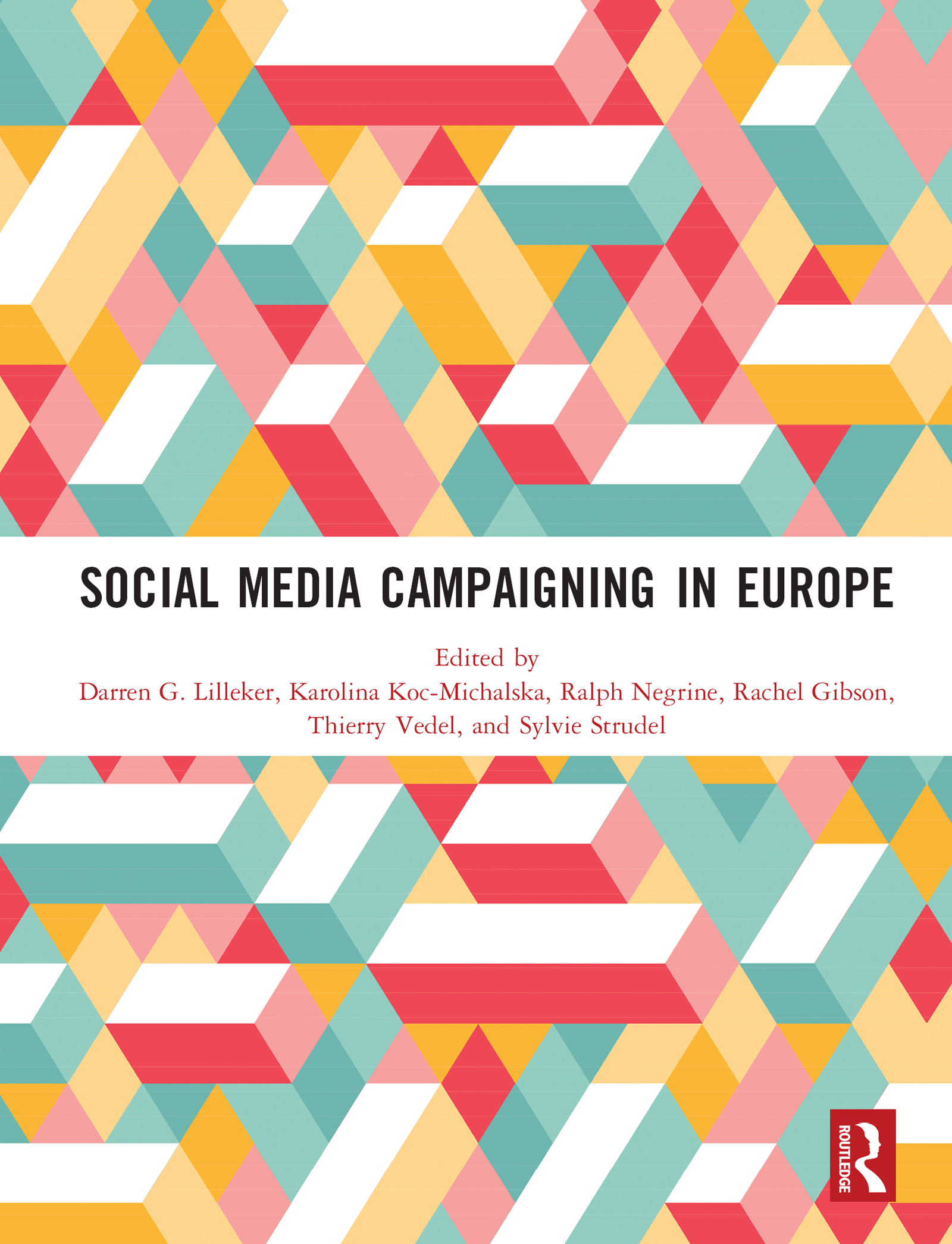
Social Media Campaigning in Europe Studies of election campaigns have shown an increased employment of websites, weblog tools, email, and social media by political campaigners, as well as the use of similar platforms by citizens to find information, communicate about elections or engage more generally in political issues. This comprehensive volume explores the ways in which social media is used on the one hand as a campaigning tool, and on the other, by local citizens. It aims to develop a more holistic and Eurocentric research agenda by capturing both supply and demand practices at the European level. The authors employ both single and multination case studies, furthering debates on how political actors and voters embrace the new information and communication environment, in what ways, and for what purposes. The book offers new perspectives on social media campaigning within European democracies, thereby contributing to a more global and comprehensive understanding of how campaigning is affected, and might be enhanced, by developing an interactive digital strategy. This book will be of great interest to students of both politics and media studies. It was originally published as a special issue of the Journal of Information Technology & Politics. POLITICAL SCIENCE,General
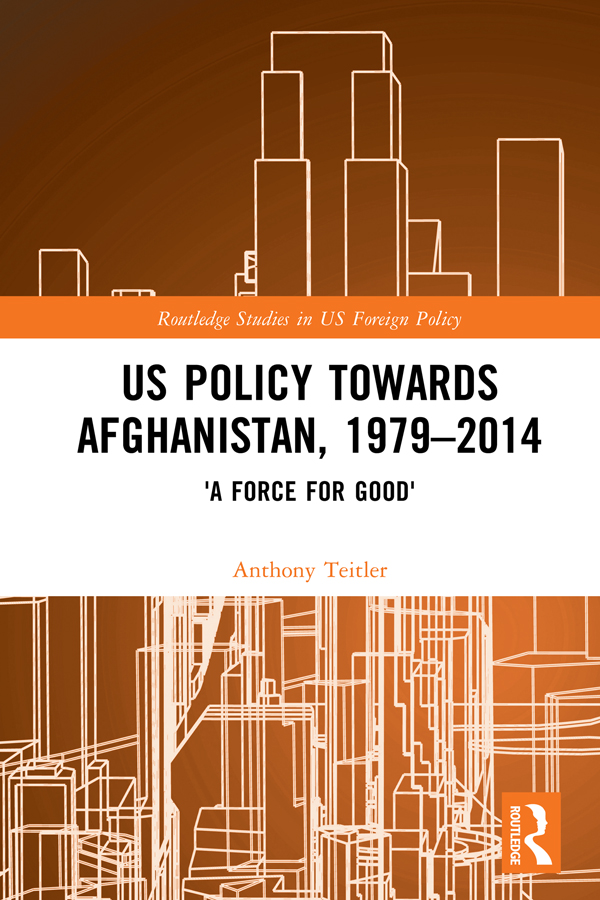
US Policy Towards Afghanistan, 1979-2014 Providing a study of US policy towards Afghanistan from the Soviet intervention of 1979 to the exit of US/International Security Assistance Forces combat troops at the end of 2014, this book examines how the United States’ construction of its interests has shaped its long-term involvement with that country. Recognising that there is a particular focus on the United States’ representation and justification of its Afghan policy, this work demonstrates how the intertwining of language and social practices provided policymakers’ with a shared meaning on selling policy. In this way, Washington justified its practices – including covert operations, diplomacy, counterterrorism and war – as essential in ensuring that ‘good’ prevailed over ‘evil’. Teitler’s argument contrasts with the existing literature, which predominantly argues the United States has been motivated by self-interest in its dealings with Afghanistan. Teitler deploys a constructivist approach to elucidate US–Afghan relations in this critical historical juncture. Through its particular use of constructivism, the work aims to contribute more broadly to international relations and US foreign policy scholarship. This book will be of interest to academics and students in various fields, including US foreign and security policy, international relations theory, the Greater Middle East, Afghanistan, American exceptionalism, constructivism and discourse analysis. POLITICAL SCIENCE,General

Migrating Borders Migrating Borders explores the relationship between territory and citizenship at a time when the very boundaries of the political community come into question. Made up of an interdisciplinary team of social scientists, the book provides new answers to the age-old ‘question of nationalities’ as it unfolds in a particular context – the European multilevel federation – where polities are linked to each other through a complex web of vertical and horizontal relations. Individual chapters cover and compare well-known cases such as Catalonia, Kosovo and Scotland, but also others that often fall under the radar of mainstream analysis, such as the Turkish Republic of Northern Cyprus or the Roma. At a time of heightened uncertainty surrounding the European integration project, the book offers an invaluable theoretical and empirical compass to navigate some of the most pressing issues in contemporary European politics. Exploring what happens to citizenship when borders ‘migrate’ over people, Migrating Borders will be of great interest to scholars of Ethnic and Migration Studies, European Politics and Society, Nationalism, European Integration and Citizenship. This book was originally published as a special issue of Ethnopolitics. POLITICAL SCIENCE,General

Affectedness And Participation In International Institutions Affectedness and Participation in International Institutions looks at the growing involvement of affected persons in global politics, such as young climate activists, indigenous movements, and persons affected by HIV/AIDS. Since the early 2000s, international organisations within various policy areas have increasingly recognised and involved affected persons’ organisations. This has promised to address long-standing legitimacy and democracy deficits of international policy making and norm setting. Yet, the powerful do not easily cede the terrain: Some major states, classic NGOs, and intergovernmental organisations seek to curtail the influence of the newcomers. The authors within this collection study these contestations from an interdisciplinary political science and international law perspective. Based on evidence from a broad range of policy areas, we address some of the crucial questions: What does it mean to be affected? How can affected groups meaningfully participate in international negotiations? Whose voices do still remain excluded? Ultimately, the authors chart whether the rising involvement of the 'most affected' will re-shape global politics and social struggles on the ground. Taking a dual political science and international law perspective, Affectedness and Participation in International Institutions will be of great interest to scholars of civil society in global governance, international law, and international institutions. This book was originally published as a special issue of Third World Thematics. POLITICAL SCIENCE,General
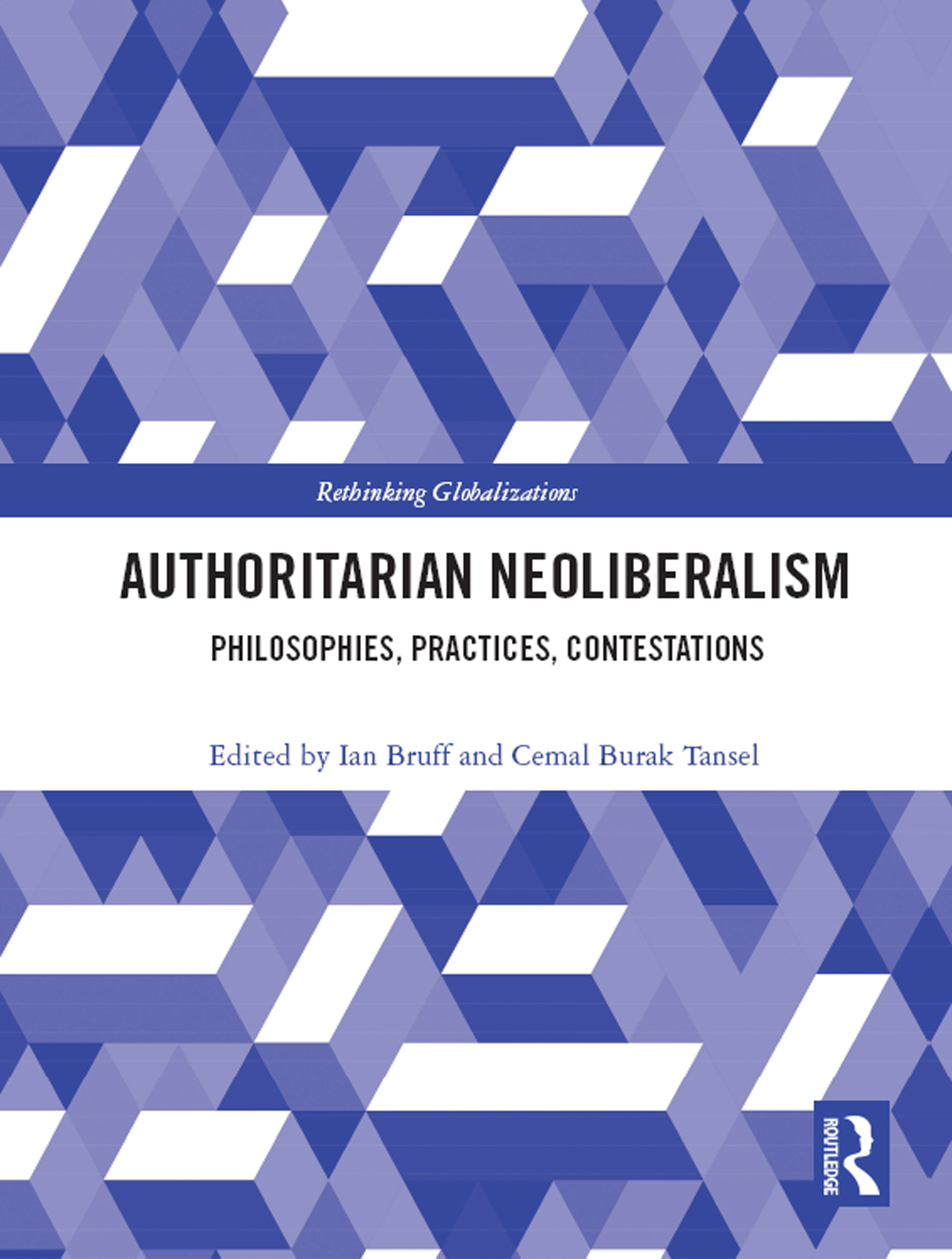
Authoritarian Neoliberalism Authoritarian Neoliberalism explores how neoliberal forms of managing capitalism are challenging democratic governance at local, national and international levels. Identifying a spectrum of policies and practices that seek to reproduce neoliberalism and shield it from popular and democratic contestation, contributors provide original case studies that investigate the legal-administrative, social, coercive and corporate dimensions of authoritarian neoliberalism across the global North and South. They detail the crisis-ridden intertwinement of authoritarian statecraft and neoliberal reforms, and trace the transformation of key societal sites in capitalism (e.g. states, households, workplaces, urban spaces) through uneven yet cumulative processes of neoliberalization. Informed by innovative conceptual and methodological approaches, Authoritarian Neoliberalism uncovers how inequalities of power are produced and reproduced in capitalist societies, and highlights how alternatives to neoliberalism can be formulated and pursued. The book was originally published as a special issue of Globalizations. POLITICAL SCIENCE,General

Post-Conflict Reconstruction The book highlights the co-relationship between post-conflict reconstruction and the containment of state fragility and violent religious extremism for attaining peaceful co-existence. POLITICAL SCIENCE,General

Between the Sword and the Wall Chronicles the peace process negotiations between Colombian president Juan Manuel Santos and the Marxist Revolutionary Armed Forces of Colombia In Between the Sword and the Wall: The Santos Peace Negotiations with the Revolutionary Armed Forces of Colombia, Harvey Kline, a noted expert on contemporary Colombian politics, brings to a close his multivolume chronicle of the incessant violence that has devastated Colombia’s population, politics, and military for decades. This, his newest work on the subject, recounts and analyzes the negotiations between Colombian president Juan Manuel Santos and the Marxist Revolutionary Armed Forces of Colombia (FARC), which ended with a peace agreement in 2016. The FARC insurgency began in 1964, and every Colombian president after 1980 unsuccessfully tried to negotiate a peace agreement with the group. Kline analyzes how the Santos administration was ultimately able to negotiate peace with the FARC. The agreement failed to receive the approval of the Colombian people in an October 2016 plebiscite, but a renegotiated version was later approved by the congress in the same year. Afterward, more than 7,000 rebels turned over their weapons to the UN mission in Colombia. The former combatants were then to be judged by a special court empowered to punish but not imprison those who had violated human rights. Throughout the book, Kline emphasizes the dual nature of the Santos negotiations, first with the FARC and second with the democratic opposition to the agreement led by former president Ãlvaro Uribe Vélez. Kline provides readers with a well-researched analysis based on a variety of resources, including media articles and primary documents from the government, international organizations, and the FARC. He also conducted extensive interviews with twenty-eight government officials and Colombian experts from all ideological persuasions. POLITICAL SCIENCE,General
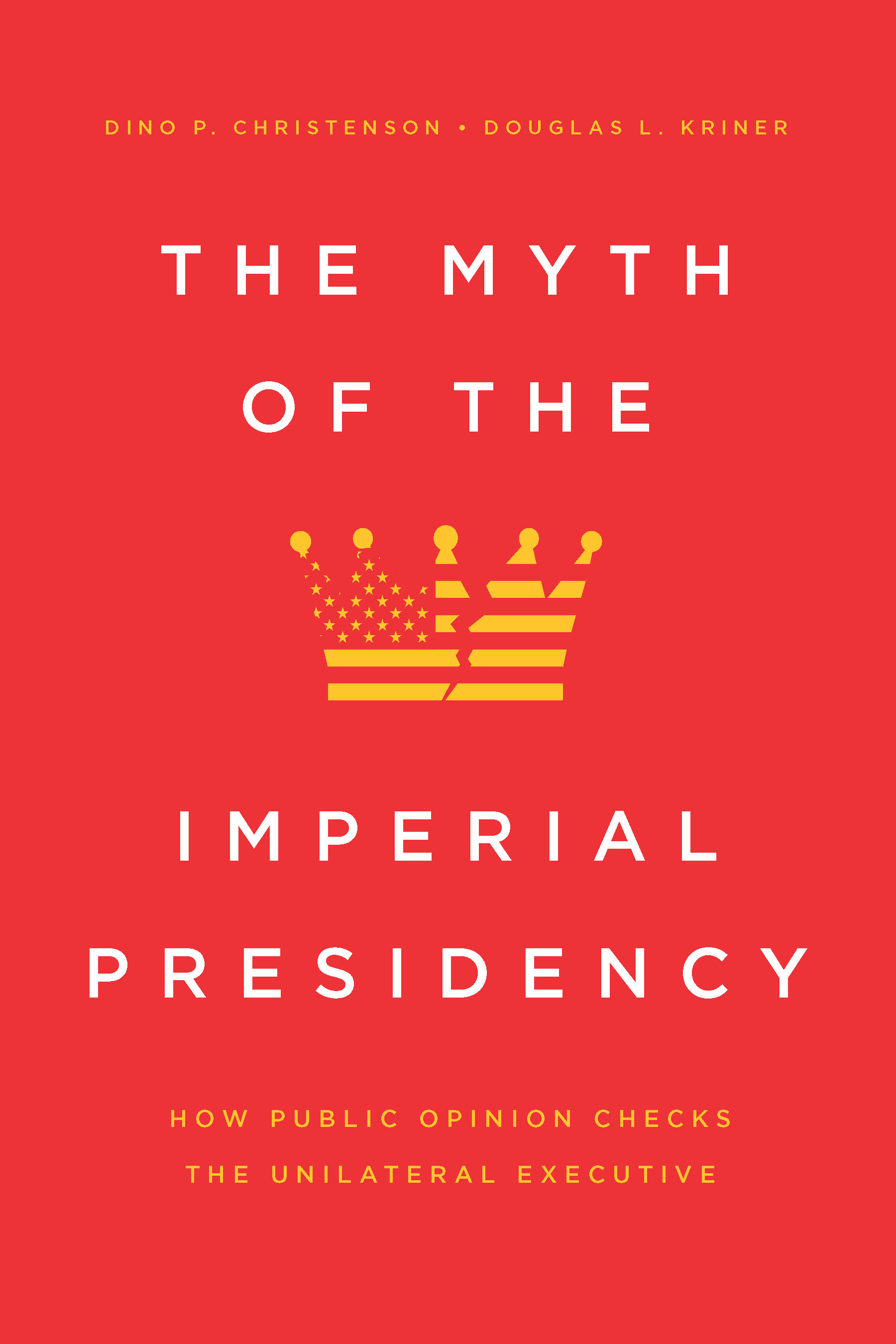
The Myth of the Imperial Presidency Throughout American history, presidents have shown a startling power to act independently of Congress and the courts. On their own initiative, presidents have taken the country to war, abolished slavery, shielded undocumented immigrants from deportation, declared a national emergency at the border, and more, leading many to decry the rise of an imperial presidency. But given the steep barriers that usually prevent Congress and the courts from formally checking unilateral power, what stops presidents from going it alone even more aggressively? The answer, Dino P. Christenson and Douglas L. Kriner argue, lies in the power of public opinion. With robust empirical data and compelling case studies, the authors reveal the extent to which domestic public opinion limits executive might. Presidents are emboldened to pursue their own agendas when they enjoy strong public support, and constrained when they don’t, since unilateral action risks inciting political pushback, jeopardizing future initiatives, and further eroding their political capital. Although few Americans instinctively recoil against unilateralism, Congress and the courts can sway the public’s view via their criticism of unilateral policies. Thus, other branches can still check the executive branch through political means. As long as presidents are concerned with public opinion, Christenson and Kriner contend that fears of an imperial presidency are overblown. POLITICAL SCIENCE,General
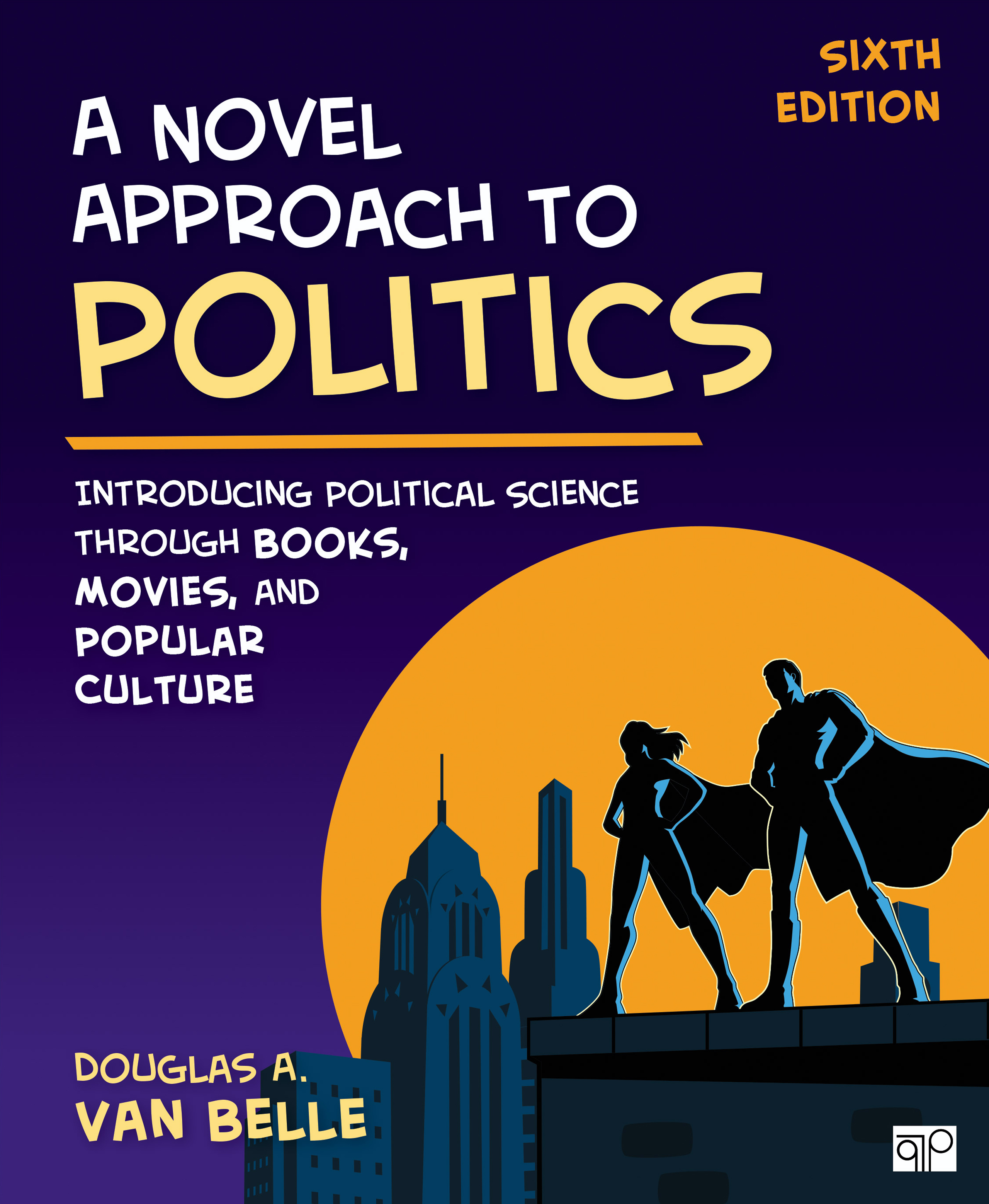
A Novel Approach to Politics A textbook you will want to read. A Novel Approach to Politics turns the conventional textbook wisdom on its head by using pop culture references to illustrate key concepts and cover recent political events. Adopters of previous editions are thanking author Douglas A. Van Belle for some of their best student evaluations to date. With this Sixth Edition, Van Belle brings the book fully up-to-date with current events and policy debates, international happenings, and other assorted ‘intergalactic’ matters. Van Belle tackles the most tumultuous political periods in recent history head-on, encouraging you to engage with ideas, arguments, and information that might make you uncomfortable. Employing a wide range of references from Brooklyn Nine-Nine to The Good Place to Ready Player One, you are given a solid grounding in institutions, ideology, and economics. To keep things grounded, the textbook nuts and bolts are still there to aid you, including chapter objectives, chapter summaries, bolded key terms, and discussion questions. POLITICAL SCIENCE,General
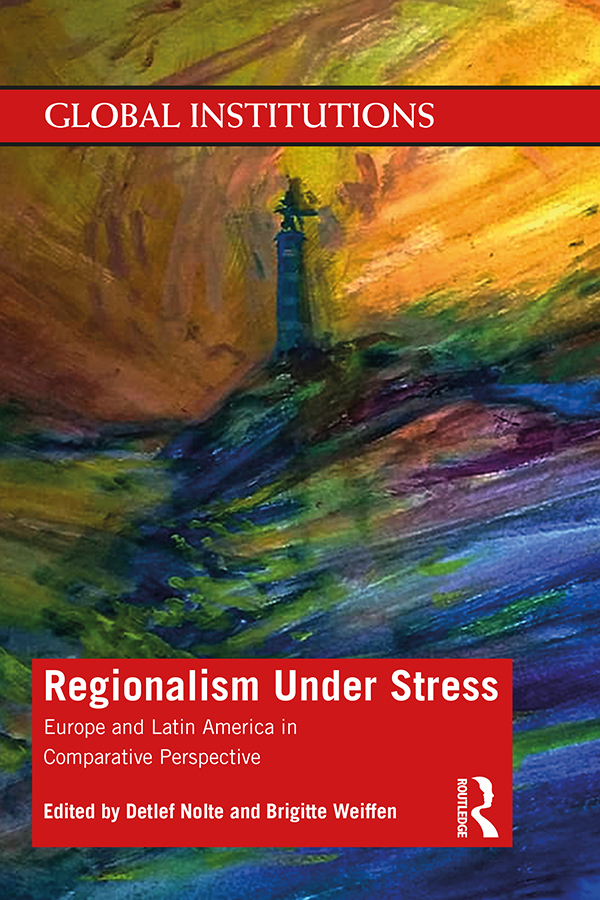
Regionalism Under Stress Regionalism is under stress. The European Union has been challenged by the Eurozone crisis, refugee flows, terrorist attacks, Euroscepticism, and Brexit. In Latin America, regional cooperation has been stagnating. Studying Europe and Latin America within a broader comparative perspective, this volume provides an analytical framework to assess stress factors facing regionalism. The contributors explore how economic and financial crises, security challenges, identity questions raised by immigration and refugee flows, the rise of populism, and shifting regional and global power dynamics have had an impact on regionalism; whether the EU crisis has had repercussions for regionalisms in other parts of the world; and to what extent the impact of stress factors is mediated by characteristics of the region that may provide elements of resilience. Written by specialists from Europe and Latin America with a shared interest in the new field of comparative regionalism, this book will be an invaluable resource for students, scholars and policy specialists in regional integration, European politics, EU studies, Latin American studies, and international relations and international law more generally. POLITICAL SCIENCE,General

Class, Gender and Migration Using a gender-sensitive political economy approach, this book analyzes the emergence of new migration patterns between Central Mexico and the East Coast of the United States in the last decades of the twentieth century, and return migration during and after the global economic crisis of 2007. Based on ethnographic research carried out over a decade, details of the lives of women and men from two rural communities reveal how neoliberal economic restructuring led to the deterioration of livelihoods starting in the 1980s. Similar restructuring processes in the United States opened up opportunities for Mexican workers to labor in US industries that relied heavily on undocumented workers to sustain their profits and grow. When the Great Recession hit, in the context of increasingly restrictive immigration policies, some immigrants were more likely to return to Mexico than others. This longitudinal study demonstrates how the interconnections among class and gender are key to understanding who stayed and who returned to Mexico during and after the global economic crisis. Through these case studies, the authors comment more widely on how neoliberalism has affected the livelihoods and aspirations of the working classes. This book will be of key interest to scholars, students and practitioners in migration studies, gender studies/politics, and more broadly to international relations, anthropology, development studies, and human geography. POLITICAL SCIENCE,General
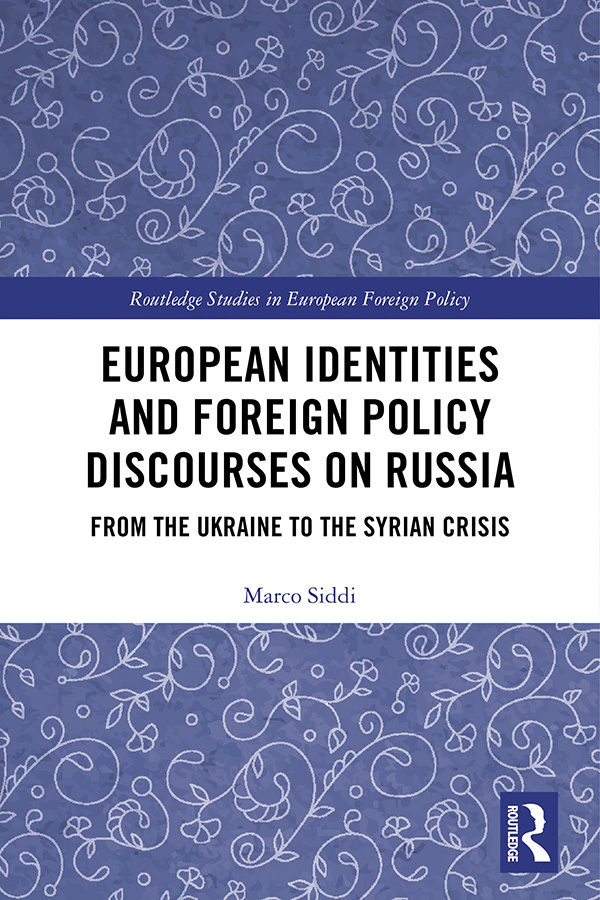
European Identities and Foreign Policy Discourses on Russia This book examines the relationship between national identity construction and current foreign policy discourses on Russia in selected European Union member states in 2014–2018. It shows that divergent national discourses on Russia derive from the different ways in which the country was constructed in national identity. The book develops an interpretive theoretical framework and argues that policy makers’ agency can profoundly influence the contestation between different identity narratives. It includes case studies in policy areas that are of primary importance for EU–Russia relations, such as energy security (the Nord Stream 2 controversy), the Ukraine crisis and Russia’s military intervention in Syria. Focusing on EU member states that have traditionally taken different stances vis-à -vis Russia (Germany, Poland and Finland), it shows that at the peak of the Ukraine crisis national discourses converged towards a pragmatic, but critical narrative. As the Ukraine crisis subsided and new events took centre stage in foreign policy discussions (i.e. the Syrian civil war, international terrorism), long-standing and identity-based divergences partly re-emerged in the discourses of policy makers. This became particularly evident during the Nord Stream 2 controversy. Deep-rooted and different perceptions of the Russian Other in EU member states are still influential and lead to divergent national agendas for foreign policy towards Russia. This book will be of interest to students and scholars working in European and EU politics, Russian and Soviet politics, and International Relations. POLITICAL SCIENCE,General

Italy Transformed The decade commencing with the great crash of 2008 was a watershed period for Italian politics, involving fundamental and dramatic changes, many of which had not been anticipated and which are charted in this book. This comprehensive volume covers the impact of the Eurozone crisis on the Italian economy and its relationship with the European Union, the dramatic changes in the political parties (and particularly the rise of a new political force, the Five Star Movement, which became the largest political party in 2013), the changing role of the Trade Unions in the lives of Italian citizens, the Italian migration crisis, electoral reforms and their impact on the Italian party system (where trends towards bipolarisation appear to be exhausted), the rise of new forms of social protest, changes to political culture and social capital and, finally, amidst the crisis, reforms to the welfare state. Overall, the authors reveal a country, which many had assumed was in quiet transition towards a more stable democracy, that suffers an immense shock from the Eurozone crisis and bringing to the fore deep-rooted structural problems which have changed the dynamics of its politics, as confirmed in the outcome to the 2018 National Elections. This book was originally published as a special issue of South European Society and Politics. POLITICAL SCIENCE,General
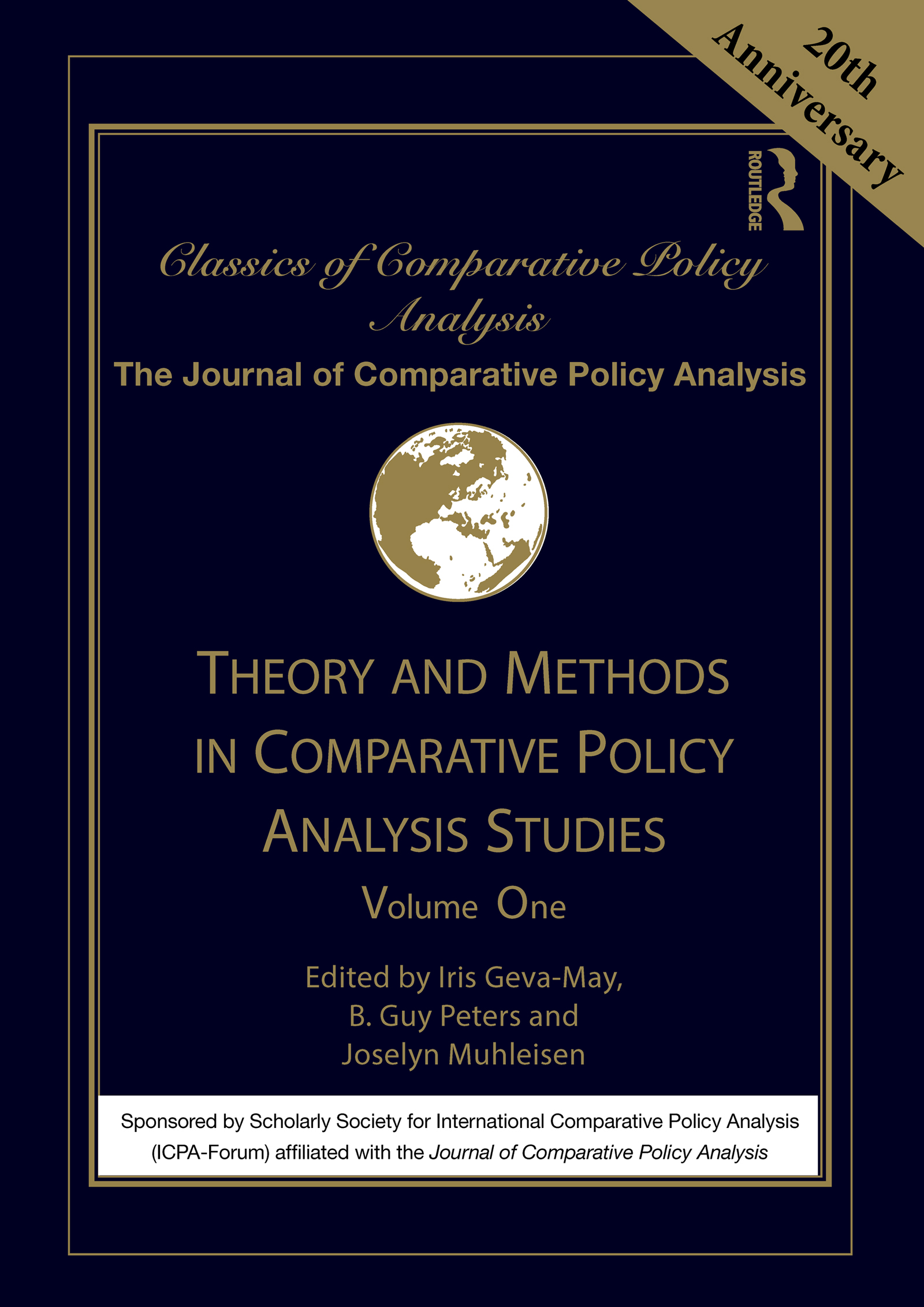
Theory and Methods in Comparative Policy Analysis Studies Volume One of the Classics of Comparative Policy Analysis, "Theory and Methods in Comparative Policy Analysis Studies" includes chapters that apply or further theory and methodology in the comparative study of public policy, in general, and policy analysis, in particular. Throughout the volume the chapters engage in theory building by assessing the relevance of theoretical approaches drawn from the social sciences, as well as some which are distinctive to policy analysis. Other chapters focus on various comparative approaches based on developments and challenges in the methodology of policy analysis. Together, this collection provides a comprehensive scholastic foundation to comparative policy analysis and comparative policy studies. "Theory and Methods in Comparative Policy Analysis Studies" will be of great interest to scholars and learners of public policy and social sciences, as well as to practitioners considering what can be learned or facilitated through methodologically and theoretically sound approaches. The chapters were originally published as articles in the Journal of Comparative Policy Analysis which in the last two decades has pioneered the development of comparative public policy. The volume is part of a four-volume series, the Classics of Comparative Policy Analysis including Theories and Methods, Institutions and Governance, Regional Comparisons, and Policy Sectors. Each volume showcases a different new chapter comparing domains of study interrelated with comparative public policy: political science, public administration, governance and policy design, authored by the JCPA co-editors Giliberto Capano, Iris Geva-May, Michael Howlett, Leslie A. Pal and B. Guy Peters. POLITICAL SCIENCE,General
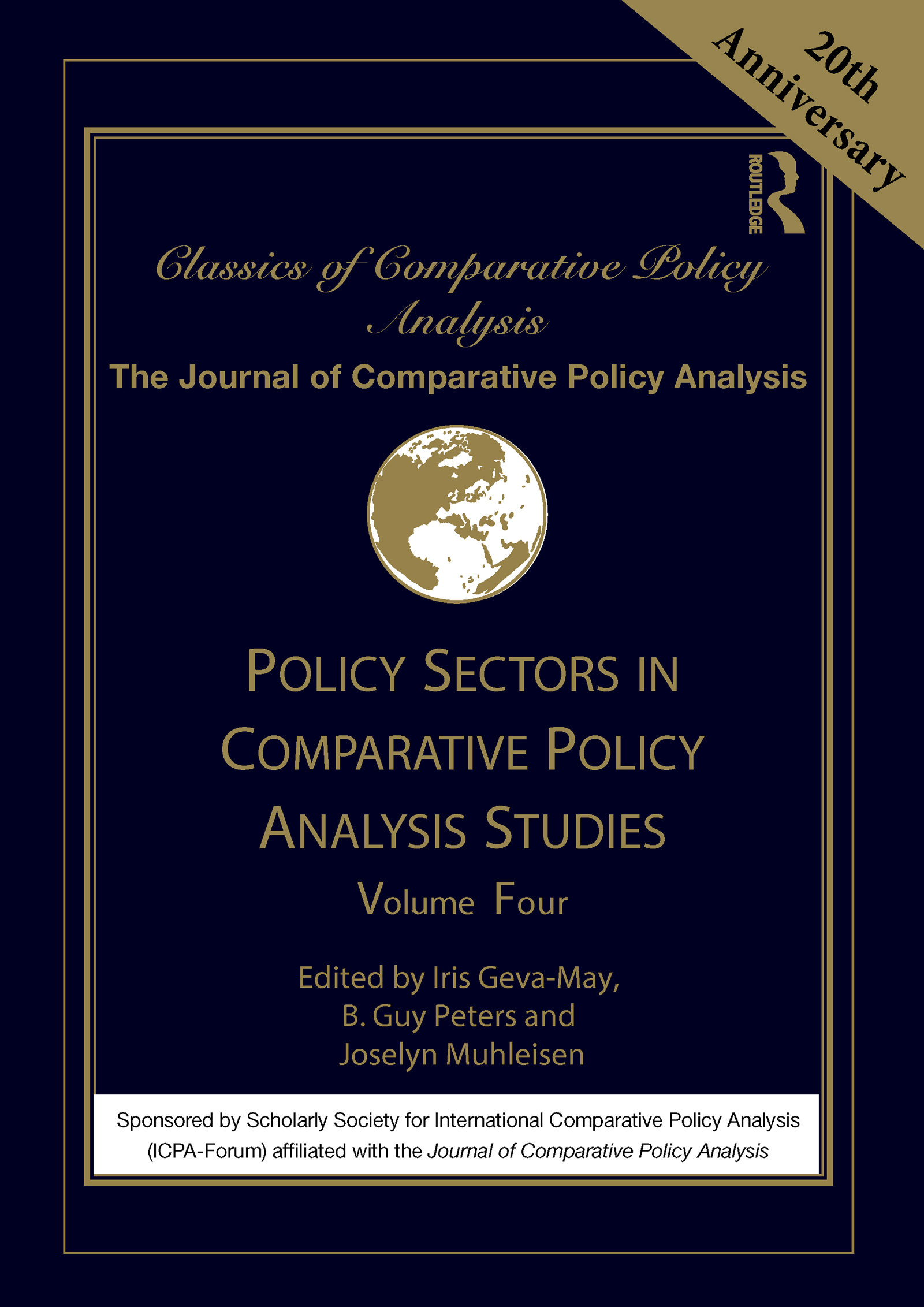
Policy Sectors in Comparative Policy Analysis Studies Volume Four of the Classics of Comparative Policy Analysis, "Policy Sectors in Comparative Policy Analysis Studies" contains chapters concerned with comparison within disciplinary policy sectors. The volume contains detailed analyses of policies within six major policy sectors, and illustrates the important differences that exist across policies healthcare, environment, education, social welfare, immigration, and science and technology.The reader will find some common aspects and dimensions – theoretical or methodological – across all policy domains, as well as differences dictated by the characteristics of the discipline or the locus in which the policy point at issue takes place. Indeed, some scholars have argued that the differences and similarities that exist across and within policy sectors can transcend the differences or similarities across political systems. "Policy Sectors in Comparative Policy Analysis Studies" will be of great interest to scholars and learners of public policy and social sciences, as well as to practitioners considering what can be reliably contextualized, learned, facilitated or avoided through lesson-drawing. The chapters were originally published as articles in the Journal of Comparative Policy Analysis which in the last two decades has pioneered the development of comparative public policy. The volume is part of a four-volume series, the Classics of Comparative Policy Analysis including Theories and Methods, Institutions and Governance, Regional Comparisons, and Policy Sectors. Each volume showcases a different new chapter comparing domains of study interrelated with comparative public policy: political science, public administration, governance and policy design, authored by the JCPA authored by the JCPA co-editors Giliberto Capano, Michael Howlett, Leslie A. Pal and B. Guy Peters. POLITICAL SCIENCE,General
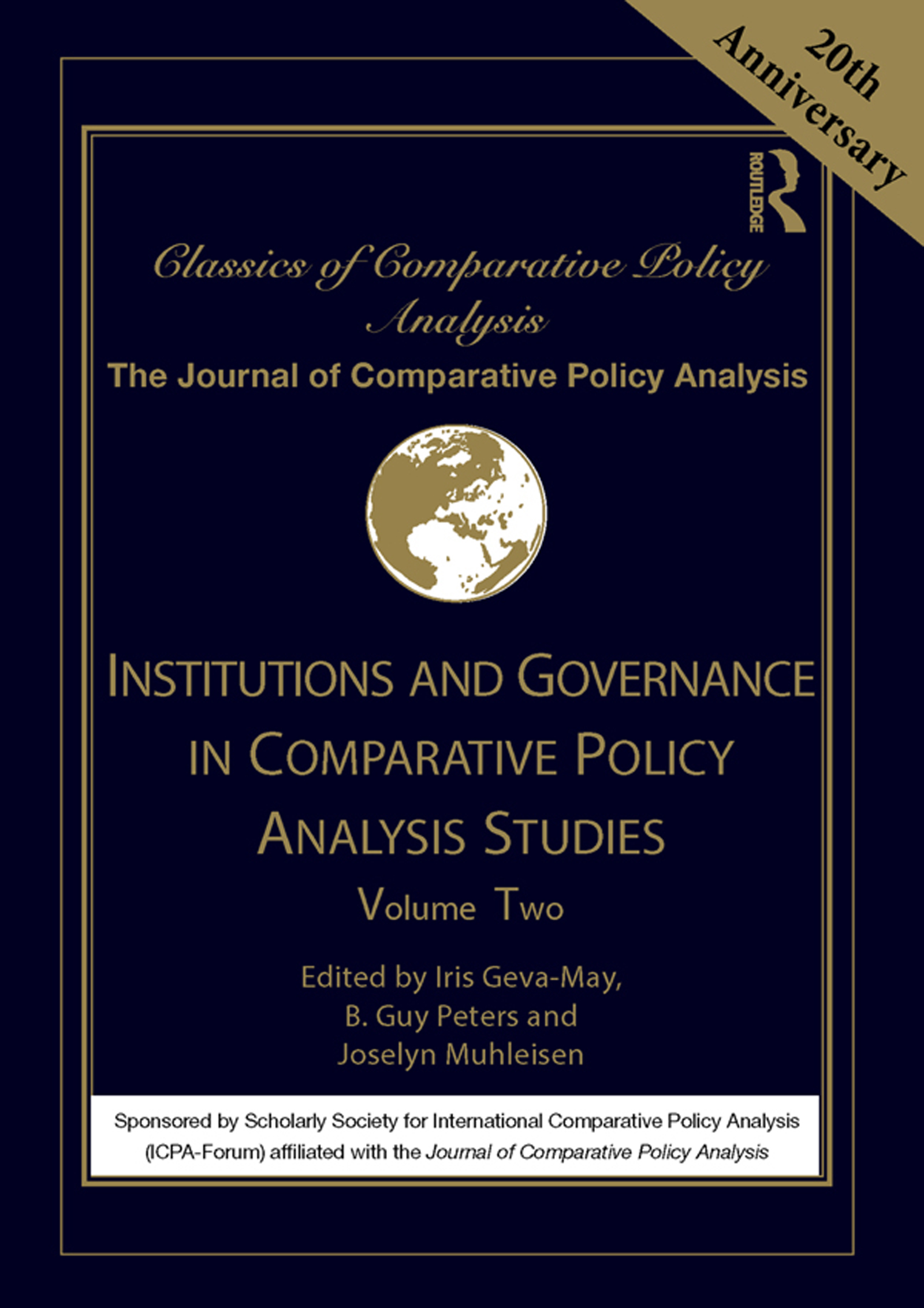
Institutions and Governance in Comparative Policy Analysis Studies Volume Two of the Classics of Comparative Policy Analysis, contains chapters concerned with "Institutions and Governance in Comparative Policy Analysis Studies". They highlight that at the core of any policy making, the different institutions and modes of governance have a significant effect. Questions about the impact of governance have become more central to comparative policy analysis as scholars have given more attention to globalization, organizational cultural differences, policy learning, transfer, and diffusion. The chapters included in this volume tackle the nature of policies and policy analytic practices within and across organizations, actors and institutions as well as among governance modes. The chapters demonstrate the ways in which institutions and governance in the public and private sectors, shape policies, and conversely, how policy choices can shape the institutions associated with them. Other chapters focus on how the diffusion of knowledge and lesson drawing address challenges of policy making, cooperation and harmonization. "Institutions and Governance in Comparative Policy Analysis Studies" will be of great interest to scholars and learners of public policy and social sciences, as well as to practitioners considering what can be reliably contextualized, learned, facilitated or avoided given their own institutional or governance systems. The chapters were originally published as articles in the Journal of Comparative Policy Analysis which in the last two decades has pioneered the development of comparative public policy. The volume is part of a four-volume series, the Classics of Comparative Policy Analysis including Theories and Methods, Institutions and Governance, Regional Comparisons, and Policy Sectors. Each volume also showcases a new chapter comparing interrelated domains of study with comparative public policy: political science, public administration, governance and policy design, authored by JCPA co-editors Giliberto Capano, Iris Geva-May, Michael Howlett, Leslie Pal and B. Guy Peters. POLITICAL SCIENCE,General

The European Union Beyond the Polycrisis? The European Union beyond the Polycrisis? explores the political dynamics of multiple crises faced by the EU, both at European level and within the member states. In so doing, it provides a state-of-the-art overview of current research on the relationship between politicization and European integration. The book proposes that the EU’s multi-dimensional crisis can be seen as a multi-level ‘politics trap’, from which the Union is struggling to escape. The individual contributions analyze the mechanisms of this trap, its relationship to the multiple crises currently faced by the EU, and the strategies pursued by a plurality of actors (the Commission, the European Parliament, national governments) to cope with its constraints. Overall, the book suggests that comprehensive, ‘grand’ bargains are for the moment out of reach, although national and supranational actors can find ways of ‘relaxing’ the politics trap and in so doing perhaps lay the foundations for more ambitious future solutions. This book, dedicated to the exploration of the political dynamics of multiple, simultaneous crises, offers an empirical and theoretical assessment of the existing political constraints on European integration. Analysing domestic and European political reactions to the EU’s polycrisis and assessing how EU institutions, national governments and broader publics have responded to a new era of politicization, The European Union beyond the Polycrisis? will be of great interest to scholars of European politics and the EU, as well as professionals working in EU institutions, national administrations and European advocacy groups. The chapters were originally published as a special issue of the Journal of European Public Policy. POLITICAL SCIENCE,General

Islam, Populism and Regime Change in Turkey Islam, Populism and Regime Change in Turkey explores the role of religion (Sunni, Hanefi Islam) in the transformation of Turkey under the reign of President Recep Tayyip Erdoğan and his Justice and Development Party (Adalet ve Kalkınma Partisi, AKP). The chapters argue that the Turkish understanding of secularism was also one of the building blocks and the constitutive elements of Turkey’s modernization until the rise of the AKP. Currently, however, it seems that religion has become a new or re-born element of the new Turkey and has been transforming many areas such as: the media, the Kurdish issue, implementation of the rule of law, foreign policy and gender issues. This book therefore aims to scrutinize the question: how does a religion-based transformation in Turkey influence the raison d’etat of the state, and effect in various ways different areas such as gender, foreign policy, economy and socio-political relations of various power groups within the society? Islam, Populism and Regime Change in Turkey will be of great interest to scholars of Religion and Politics, and governance in Turkey. It was originally published as a special issue of Southeast European and Black Sea Studies. POLITICAL SCIENCE,General

Women On The U.S.-Mexico Border This book illuminates the reality of border women's lives and challenges the conventional notion that women need not work for wages because they are economically supported by men. It offers insight into the lives of undocumented women. POLITICAL SCIENCE,General
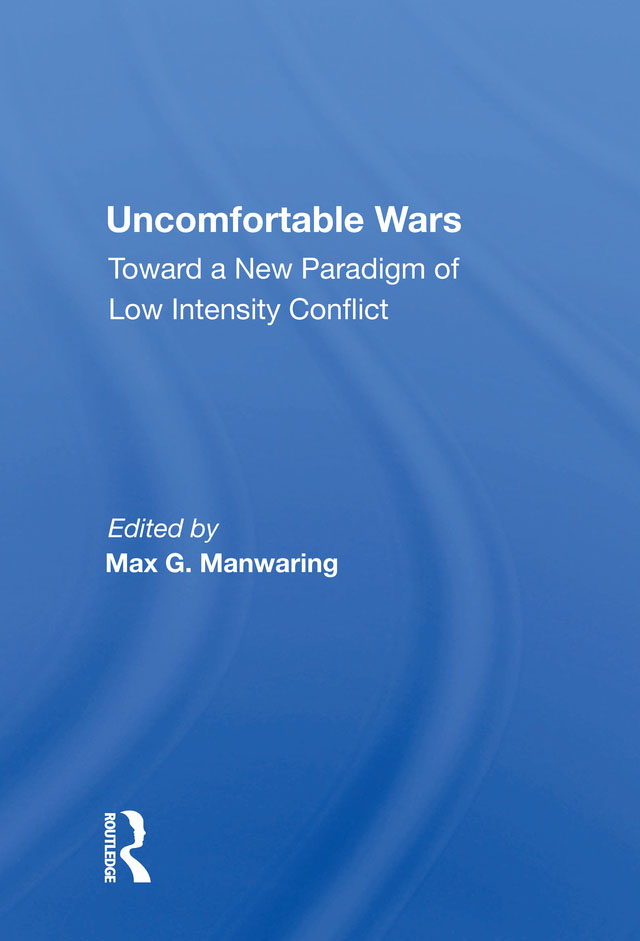
Uncomfortable Wars This volume aims to operationalize General John R. Galvin's call for a new paradigm to fight the most prevalent form of conflict in the world today-insurgency. It contributes to the understanding needed to formulate and implement efforts in the contemporary international security arena. POLITICAL SCIENCE,General
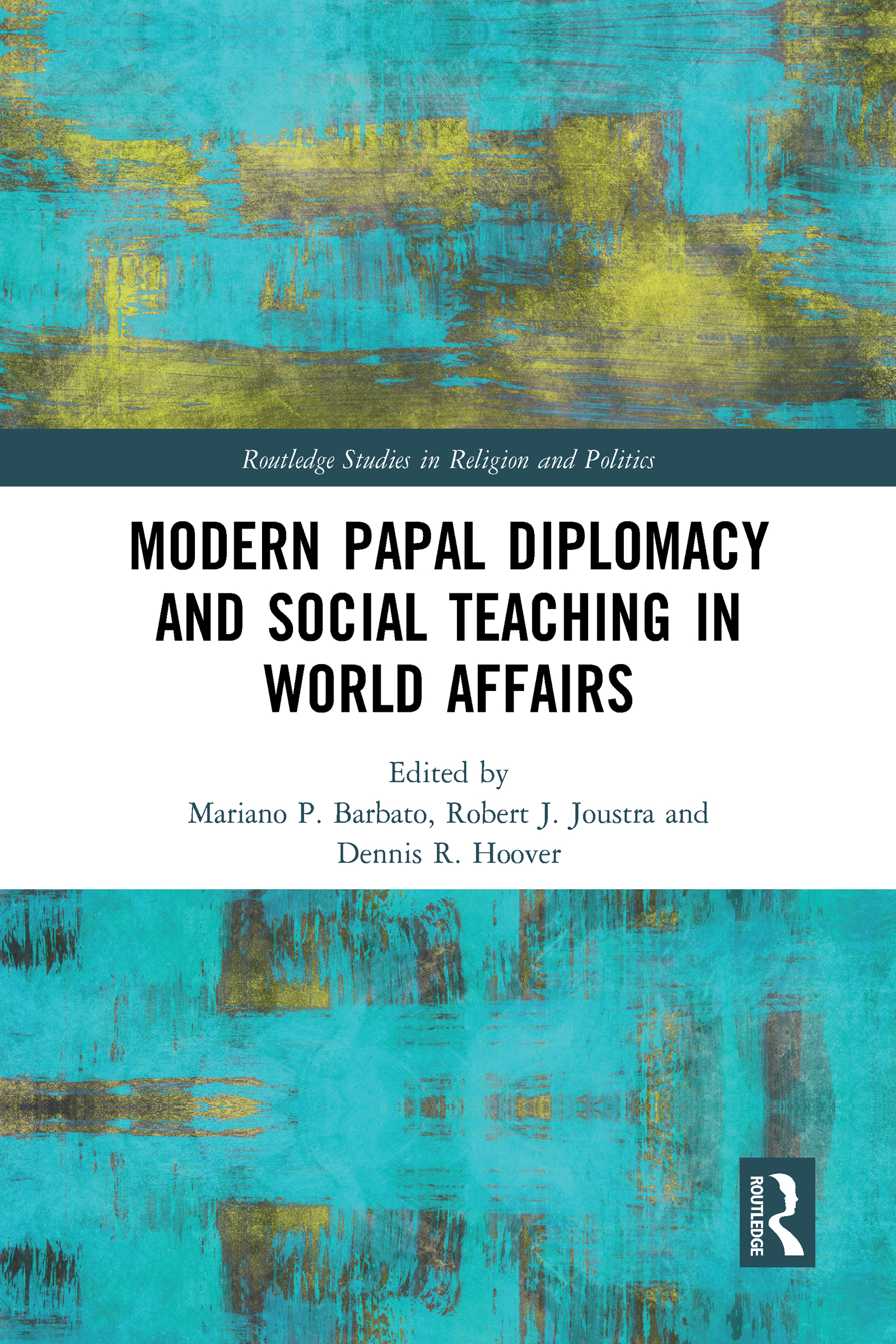
Modern Papal Diplomacy and Social Teaching in World Affairs This comprehensive collection offers a concise introduction to the institutional framework of the Holy See, conceptualizing papal agency and positions from a range of international theory perspectives. The authors – international scholars from political science, history, and religious studies – explore multiple fields of papal and Vatican influence, ranging from spy networks and inter-religious dialogue to social doctrine and religious freedom. This book demonstrates that, contrary to secularization theory, the papacy is not in decline in world politics. Since World War II, the Holy See has played a steadily increasing role in international relations. Globalization supports the role of the Catholic Church as a transnational actor not only in the advanced industrial societies of the West but also increasingly across the Global South. In this volume, the authors document the legacies of John Paul II and Benedict XVI as well as the current pontificate of Pope Francis from a range of contemporary perspectives. This book comprises research articles and commentary essays on the papacy in world politics originally published in The Review of Faith & International Affairs. POLITICAL SCIENCE,General
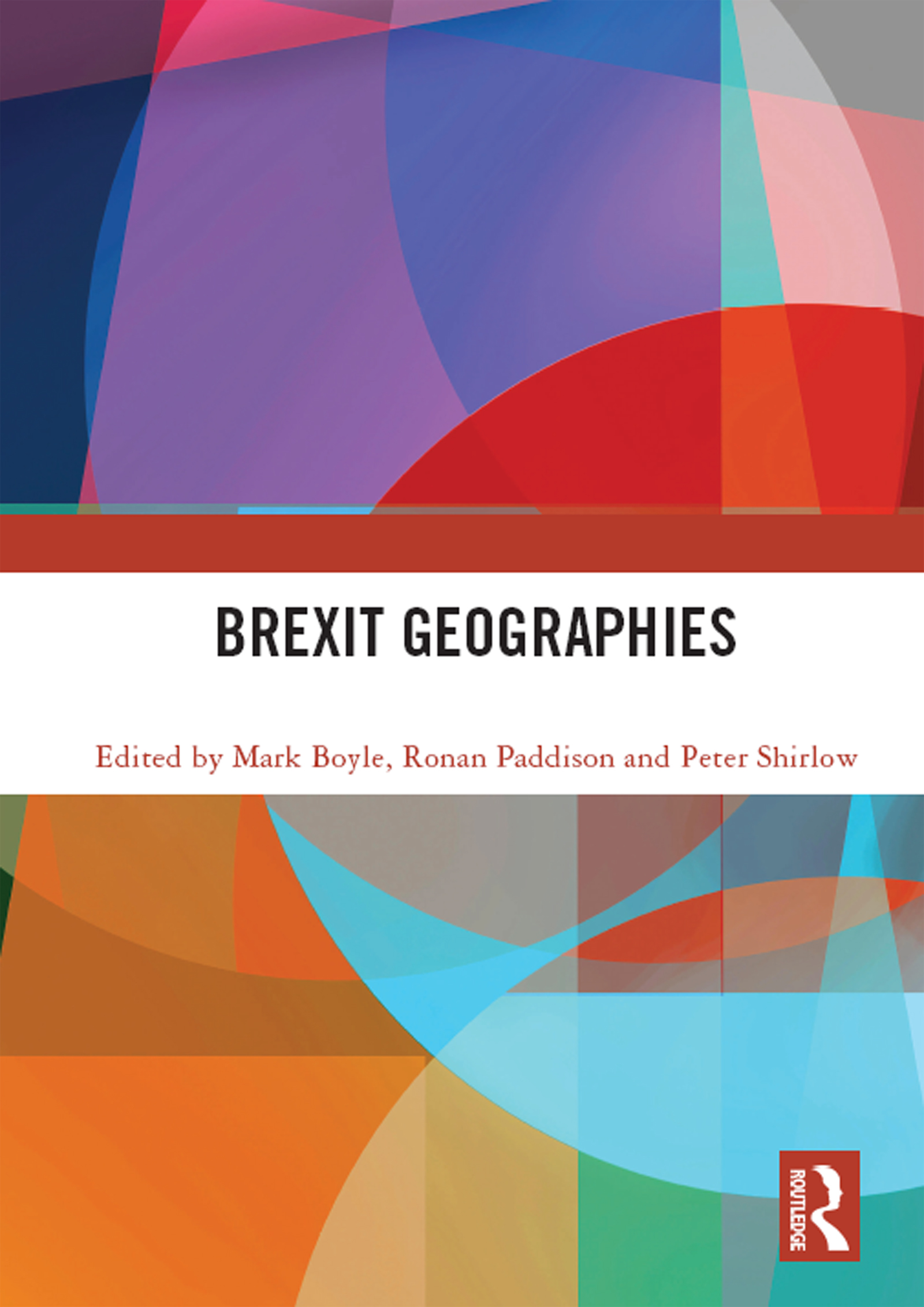
Brexit Geographies This comprehensive volume explores the political, social, economic and geographical implications of Brexit within the context of an already divided UK state. It demonstrates how support for Brexit not only sharpened differences within England and between the separate nations comprising the UK state, but also reflected how austerity politics, against which the referendum was conducted, impacted differently, with north and south, urban and rural becoming embroiled in the Leave vote. This book explores how, as the process of negotiating the secession of the UK from the EU was to demonstrate, the seemingly intractable problem of the Irish border and the need to maintain a ‘soft border’ provided a continuing obstacle to a smooth transition. The authors in this book also explore various other profound questions that have been raised by Brexit; questions of citizenship, of belonging, of the probable impacts of Brexit for key economic sectors, including agriculture, and its meaning for gender politics. The book also brings to the forefront how the UK was geographically imagined – a new lexicon of ‘left behind places’, ‘citizens of somewhere’ and ‘citizens of nowhere’ conjuring up new imaginations of the spaces and places making up the UK. This book draws out the wider implications of Brexit for a refashioned geography. It was originally published as a special issue of the journal Space and Polity. POLITICAL SCIENCE,General
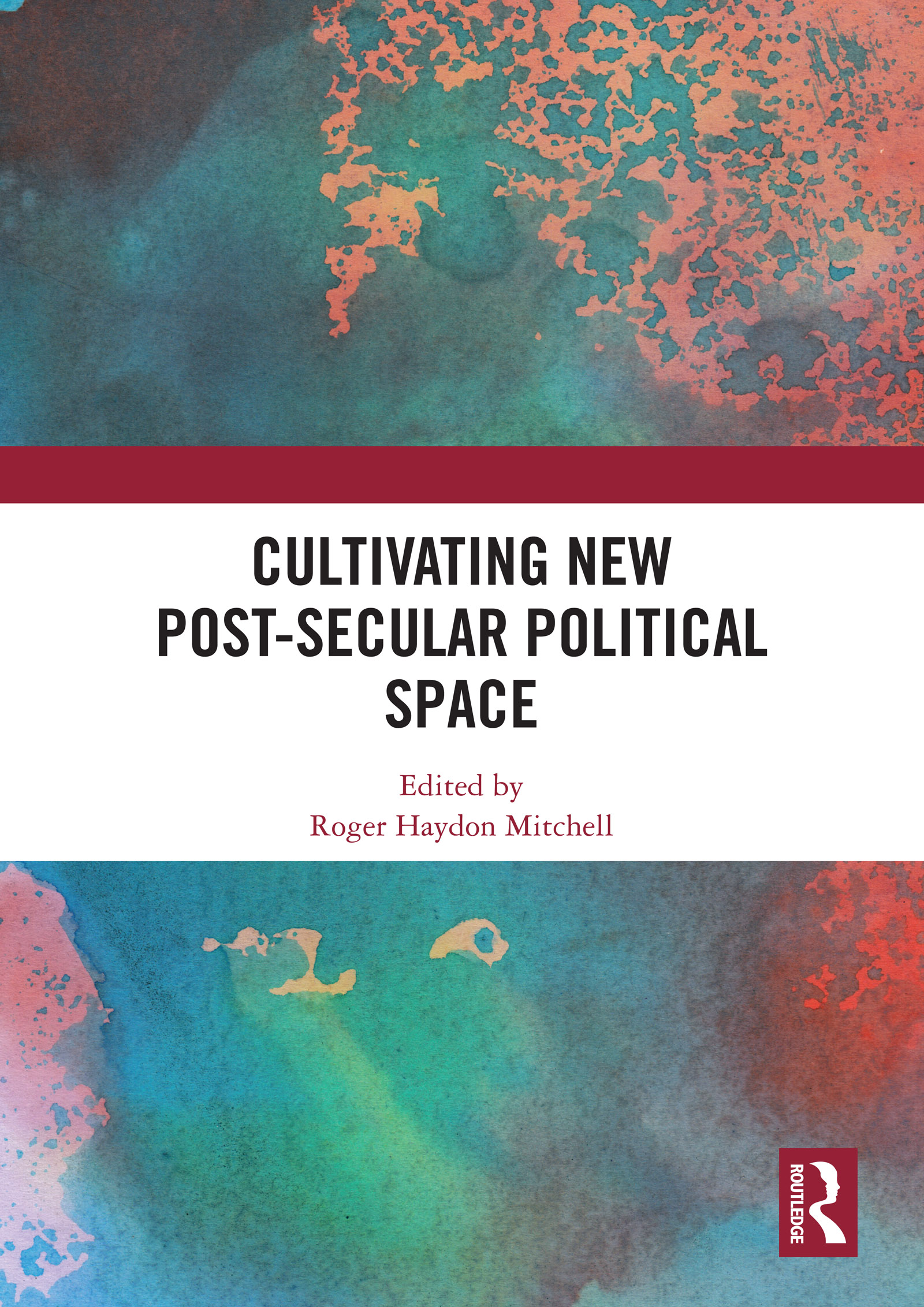
Cultivating New Post-secular Political Space This comprehensive volume provides crucial insights from contemporary academics and practitioners into how positive interventions might be made into post-secular political spaces that have emerged in the wake of the economic, political, and social upheavals of the 2008 global financial crisis. The failure of liberal democracy to deal effectively with such challenges has led to scapegoating of the poor, immigrants, and Muslims, and contributed to the populist electoral success of, among others, the Leave campaign during the 2016 United Kingdom European Union membership referendum, and Donald Trump’s Presidential campaign. These shocks have highlighted contemporary political spaces defined by what has been termed ‘all the posts’: postmodern, post-Christendom, post-liberal, post-political, and post-secular. This collection examines emerging attempts to understand and advance the cause of wellbeing within this context. The authors address a variety of key issues including: (re)configuring mythologies for the common good; deploying love and friendship politically; motivating new social movements; valuing the other; recovering displaced and devalued political narratives; finding alternatives to the previously dominant neo-liberalism; listening deeply for social transformation; and overcoming adversarial party politics. This book was originally published online as a special issue of the journal Global Discourse. POLITICAL SCIENCE,General

How Capitalism Forms Our Lives By using the concept of capitalism as a “form of lifeâ€, the authors in this volume reconceive capitalism, its mechanisms and effects on our bodies and on our common life. The idea that capitalism is more than a discrete economic system and instead a “form of life†that shapes our relationships with others, our sense of ourselves and our capacities, practices, bodies, and actions in the material world should be rather obvious. Yet efforts – whether through criticism or policy remedies – to redress the vast inequalities, inherent exploitation, alienation, and the manifold destructive effects of capitalism on the environment, typically proceed without grappling fully with the entwinement of the economic with the social and cultural, much less the ethical, ontological, and phenomenological. This volume proposes “form of life†as a heuristic tool, connecting literatures that often remain isolated from one another – the Frankfurt School, neo-materialism, Wittgenstein’s philosophy, Foucault’s and Agamben’s biopolitics, and Marx’s discussion of reproduction. In emphasizing economic practices, as opposed to capitalism as a system, they conceive of “the economic†as an integral and integrated dimension of life, and thus develop new possibilities for critique. Viewing human beings as “economic bios,†provides a needed alternative to analyses that position neoliberalism as an economic logic imposed upon the social and cultural. This book was originally published as a special issue of the Journal for Cultural Research. POLITICAL SCIENCE,General

Migration, Civil Society and Global Governance How do the United Nations, international organizations, governments, corporate actors and a wide variety of civil society organizations and regional and global trade unions perceive the root causes of migration, global inequality and options for sustainable development? This is one of the most pertinent political questions of the 21st century. This comprehensive collection examines the development of an emerging global governance on migration with the focus on spaces, roles, strategies and alliance-making of a composite transnational civil society engaged in issues of rights and the protection of migrants and their families. It reveals the need to strengthen networking and convergence among movements that adopt different entry points to the same struggle, from fighting ‘managed’ migration to contesting corporate control of food and land. The authors examine the opportunities and challenges faced by civil society in its endeavour to promote a rights-based approach within international and intergovernmental fora engaged in setting up a global compact for the management of migration, such as the Global Forum for Migration and Development, and in other global policy spaces. Chapter 1 of this book is freely available as a downloadable Open Access PDF under a CC-BY 3.0 license. https://s3-us-west-2.amazonaws.com/tandfbis/rt-files/docs/Open+Access+Chapters/9780367147266_oachapter1.pdf Chapter 3 of this book is freely available as a downloadable Open Access PDF under a CC-BY 3.0 license. https://s3-us-west-2.amazonaws.com/tandfbis/rt-files/docs/Open+Access+Chapters/9780367147266_oachapter3.pdf Chapter 6 of this book is freely available as a downloadable Open Access PDF under a CC-BY 3.0 license. https://s3-us-west-2.amazonaws.com/tandfbis/rt-files/docs/Open+Access+Chapters/9780367147266_oachapter6.pdf POLITICAL SCIENCE,General

The Difficult Construction of European Banking Union The Difficult Construction of European Banking Union examines the political, legal and economic issues surrounding the lacunae and design faults of European Banking Union and its problematic operation. The volume brings together the work of sixteen scholars focused on the diverse debates surrounding the construction and operation of Banking Union (BU), and its necessary reform. BU represents one of the most important developments in European integration since the launch of Monetary Union. Furthermore, the design of the BU agreed between 2012 and 2014 was a messy compromise among EU member states. It is not surprising then that BU has sparked a lively academic debate and triggered an ever-growing number of publications from different disciplinary backgrounds. The first wave of academic work on BU focuses upon the economic rationale underpinning the supranationalisation of control over banking — regulation, supervision, support and resolution — and the political dynamics and legal issues that shaped the design of the Union agreed. This volume is located at the intersection of this first phase of academic research and a second stage which analyses the functioning of the different elements of BU. New research questions are triggered by the albeit limited empirical evidence on BU’s implementation and operation. Contributions to this second wave of research attempt to identify potentially dangerous lacunae and contribute to on-going reform debates. The Difficult Construction of European Banking Union will be of great interest to scholars of the European Union, Banking, Economic Governance, and Political Economy. Most of the chapters were originally published as three special issues in the Journal of Economic Policy Reform. POLITICAL SCIENCE,General
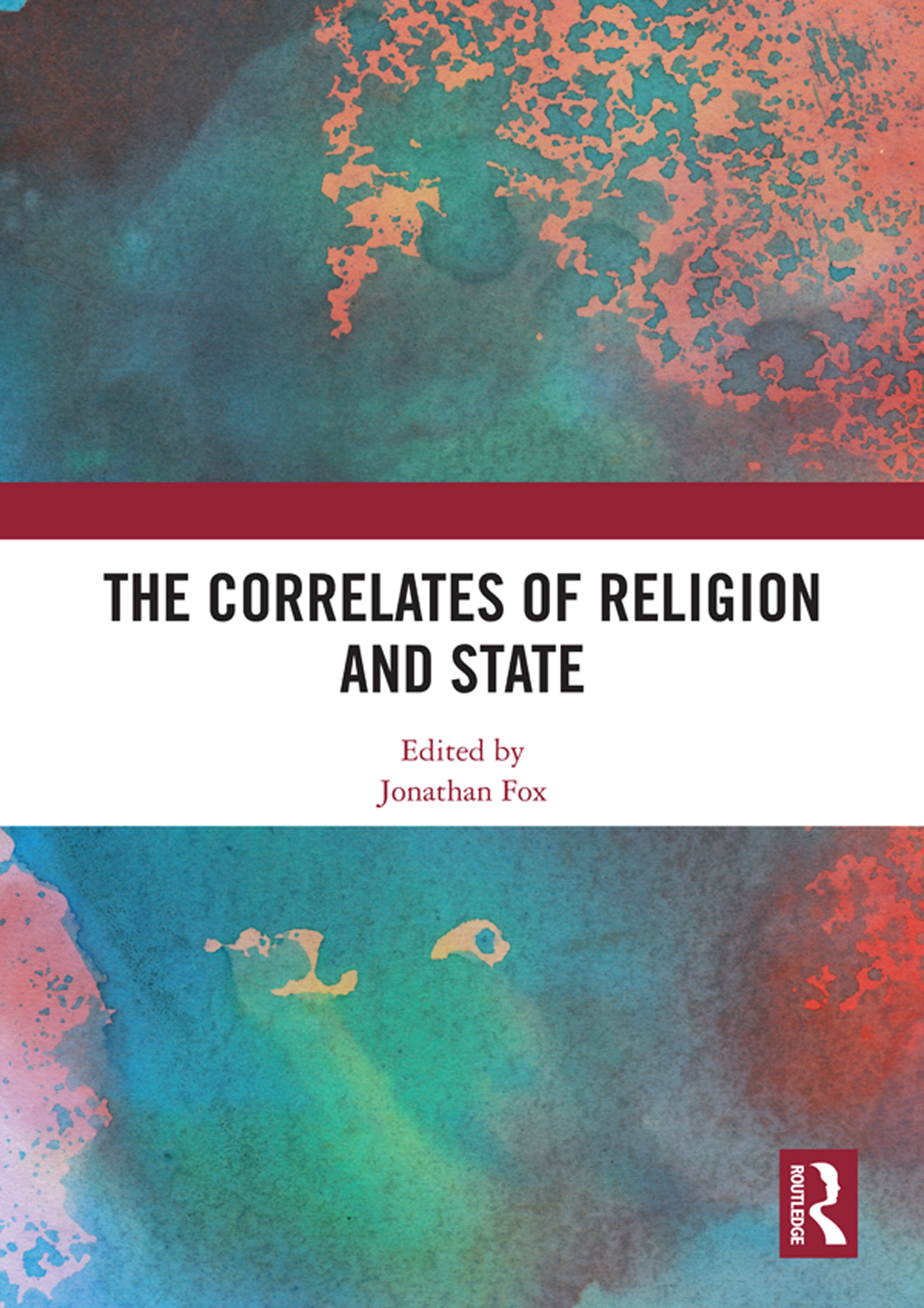
The Correlates of Religion and State This comprehensive volume examines the nature, causes, and consequences of state religion policy in 183 countries between 1990 and 2014. Each contribution uses round 3 of the Religion and State dataset which includes information on 117 distinct state religion policies. Secular and religious forces in society and government compete in order to influence state religion policy in a vibrant religious economy. While governments are more involved in religion in 2014 than they were in 1990, most states both added and dropped religion policies during this period. This is important because these policies impact on a number of important political, social, and economic phenomena. In this collection the authors examine the impact of state religion policies on interstate militarized disputes, violent domestic conflict, terrorism, and voting for political parties. They also examine some of the factors that influence state religion policy, including the attitudes of citizens toward religion and religious minorities, free and open elections, and having an independent judiciary. This book was originally published as a special issue of the journal Religion, State & Society. POLITICAL SCIENCE,General

Reoccupying the Political Focusing on the increasing refusal and transgression of politics as normal across the globe, this book examines new forms of democratisation, democratic life and political subjectivity, as people seek to gain control over the decisions and processes affecting their lives. The contributors to this volume challenge the hegemonic truth regimes of political science by bringing to our attention practices and discussions on the margins of political theorisation and conceptualisation. They offer a pluridiveristy of theorisations and engagements that mirror the very practises of democratic life of which they speak. They demonstrate how research on the margins enables us to develop and deepen our conceptualisation and engagement with these new forms of democratic thought and practice, and hence our understanding of the political and the transformation of political science. These new forms of politics call into question the epistemological authority of political science, and this book will be of interest to those seeking to understand the increasing trend towards prefigurative epistemologies, decolonising methodologies and participatory forms of becoming political. This book was originally published as a special issue of Social Identities. POLITICAL SCIENCE,General
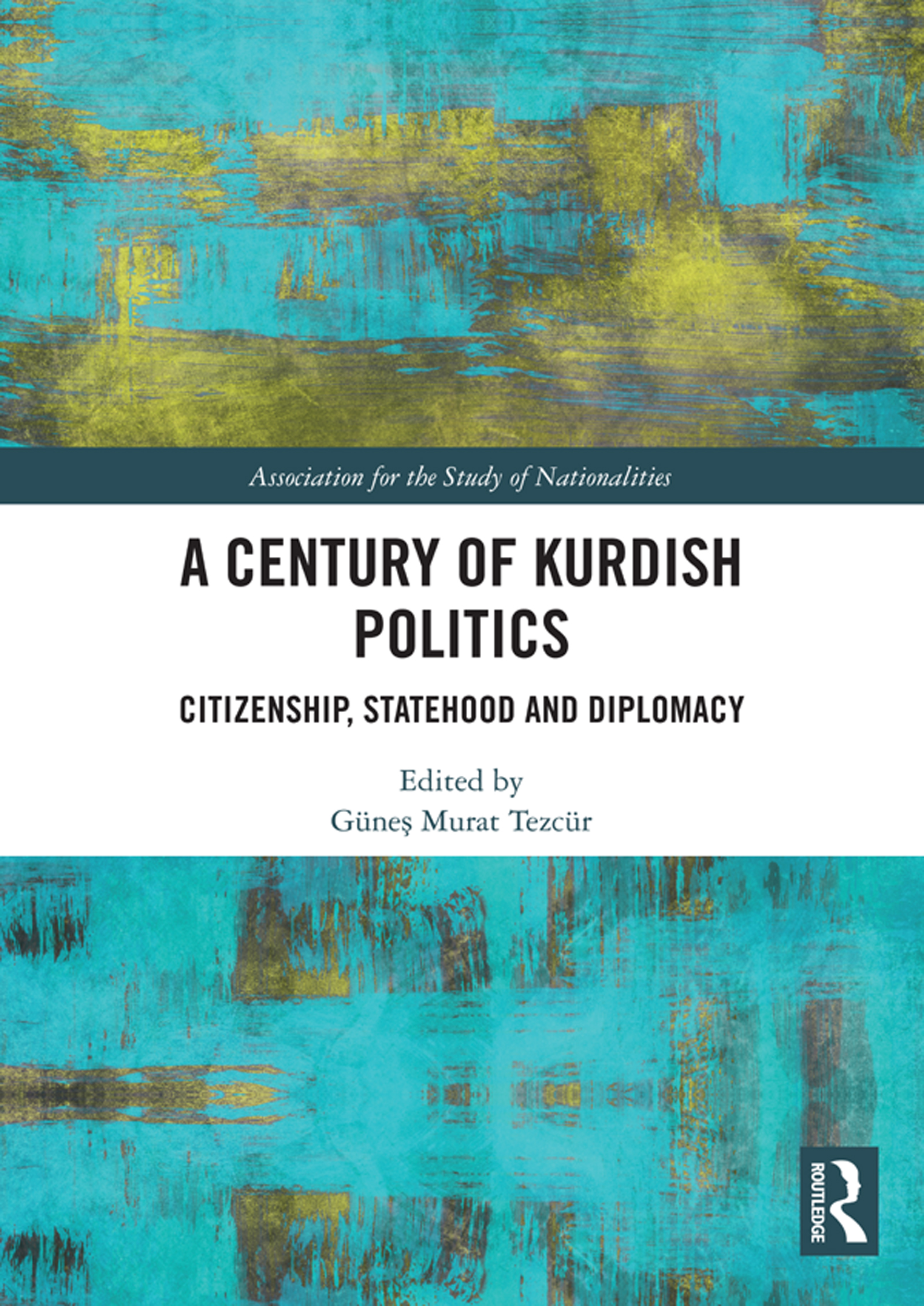
A Century of Kurdish Politics The Kurdish question remains one of the most important and complicated issues in ethnic politics in contemporary times, with the Kurds being one of the largest ethnic groups in the world without a state of their own. This comprehensive volume brings together a group of distinguished scholars to address the Kurdish question in its centennial year with a fresh analytical lens, to demonstrate that the study of Kurdish politics has developed beyond a narrow focus on the state-minority antagonism. It addresses a series of interrelated questions focusing on Kurdish politics as well as broader themes related to nationalism, ethnic mobilization, democratic struggles, and international security. The authors examine the agency of Kurdish political actors and their relations with foreign actors; the relations between Kurdish political leaders and organizations and regional and great powers; the dynamics and competing forms of Kurdish political rule; and the involvement of Kurdish parties in broader democratic struggles. Using original empirical work, they place the scholarship on Kurdish politics in dialogue with the broader scholarship on ethnic nationalism, self-determination movements, diaspora studies, and rebel diplomacy. This book was originally published as a special issue of the journal Ethnopolitics. POLITICAL SCIENCE,General
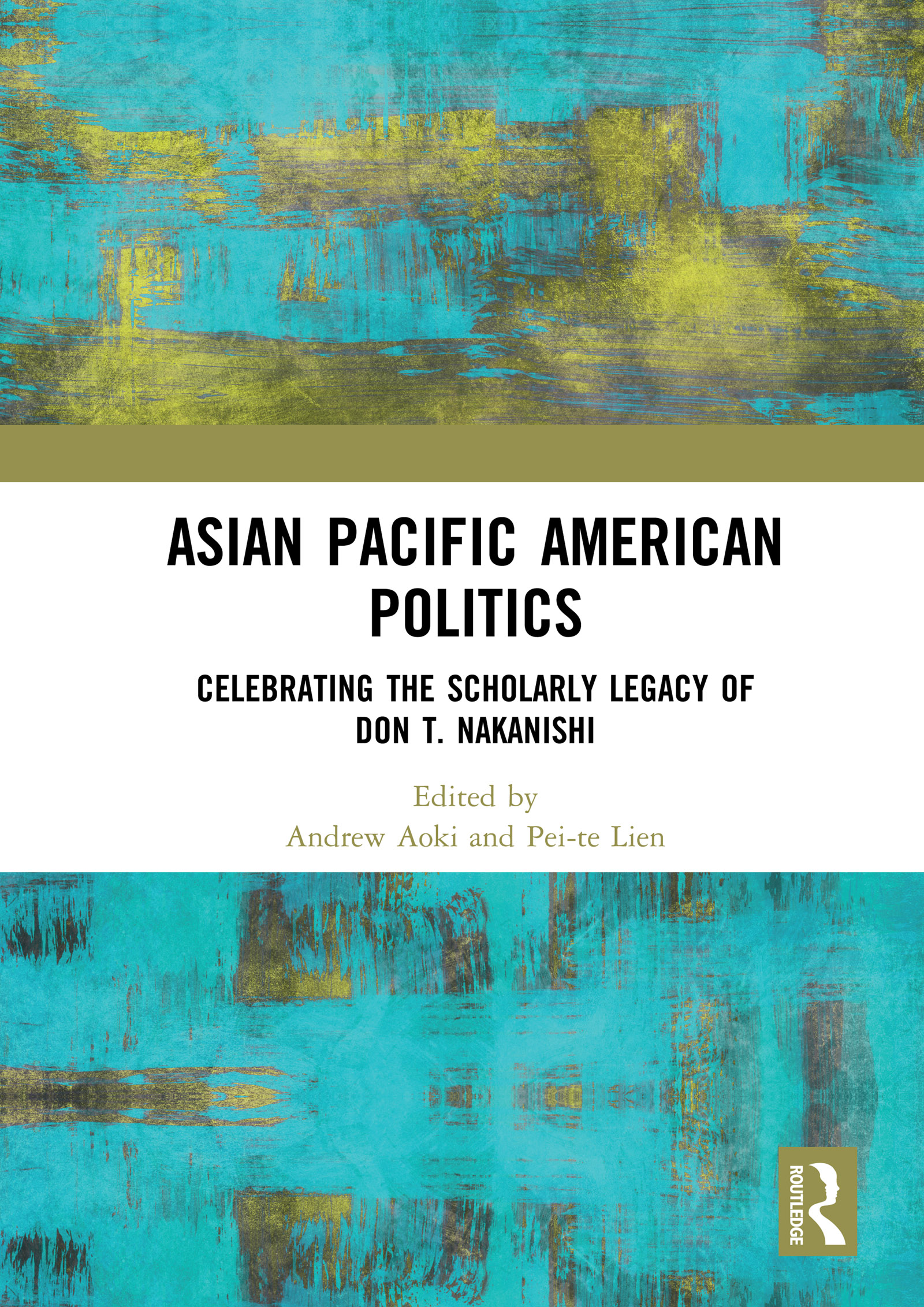
Asian Pacific American Politics Asian Pacific American Politics presents some of the most recent research on Asian American politics, including both quantitative and qualitative examinations of the role of Asian and Pacific Islander Americans in some of today’s major political controversies. In the highly polarized politics of the United States in the early 21st century, non-Black racial minorities such as Asian Americans and Pacific Islander Americans will increasingly find themselves swept into the epicenter of many of the divisive controversies. This timely volume presents the latest scholarly research on some of these issues, examining questions such as Asian American support for #Black Lives Matter, responses to racially-charged attacks, and the differences in the political socialization, politicization, and community-based activism within and across sectors of the Asian American population. In addition to examining political identity, voting participation, political mobilization, transnational politics, and partisan formation, the volume also investigates important, but little discussed, issues such as the Native Hawaiian sovereignty movement, political incorporation of Filipino Americans, and the struggle to establish "comfort women" memorials in the United States. Contributors also examine, through dialogues, how Asian Americans fit into the larger world of American racial politics, the extent to which they are likely to build coalitions with other communities of color, and the boundaries and contours of Asian American political theory. Exploring and Expanding the Political World Pioneered by Don T. Nakanishi, Asian Pacific American Politics will be of great interest to scholars of race and ethnicity in American politics, immigration and minority incorporation, ethnic identity politics, and political participation and democratic inclusion of Asians. The chapters were originally published in Politics, Groups, and Identities. POLITICAL SCIENCE,General

Rethinking Israel and Palestine The Middle East seems to be in perpetual crisis. One might expect a plethora of Marxist analyses of Israel and Palestine. Yet in the literature on Israel and Palestine there are hardly any studies of class, relations of production, or the relationship between the political and economic balance of forces over time. This edited volume brings a diverse array of Marxist-influenced interpretations of the present conjuncture in Israel and Palestine. The collection includes works by luminaries of social theory, such as Noam Chomsky and Fred Jameson, as well as leading scholars of Palestine (Raja Khalidi, Sherene Seikaly, and Orayb Aref Najjar) and Israel (Jonathan Nitzan, Nitzan Lebovic and Amir Locker-Biletzki). It comprises the first-ever collection of Marxist-influenced writings on Palestine and Israel, and the relationship between them. This book was originally published as a special issue of the journal Rethinking Marxism. POLITICAL SCIENCE,General
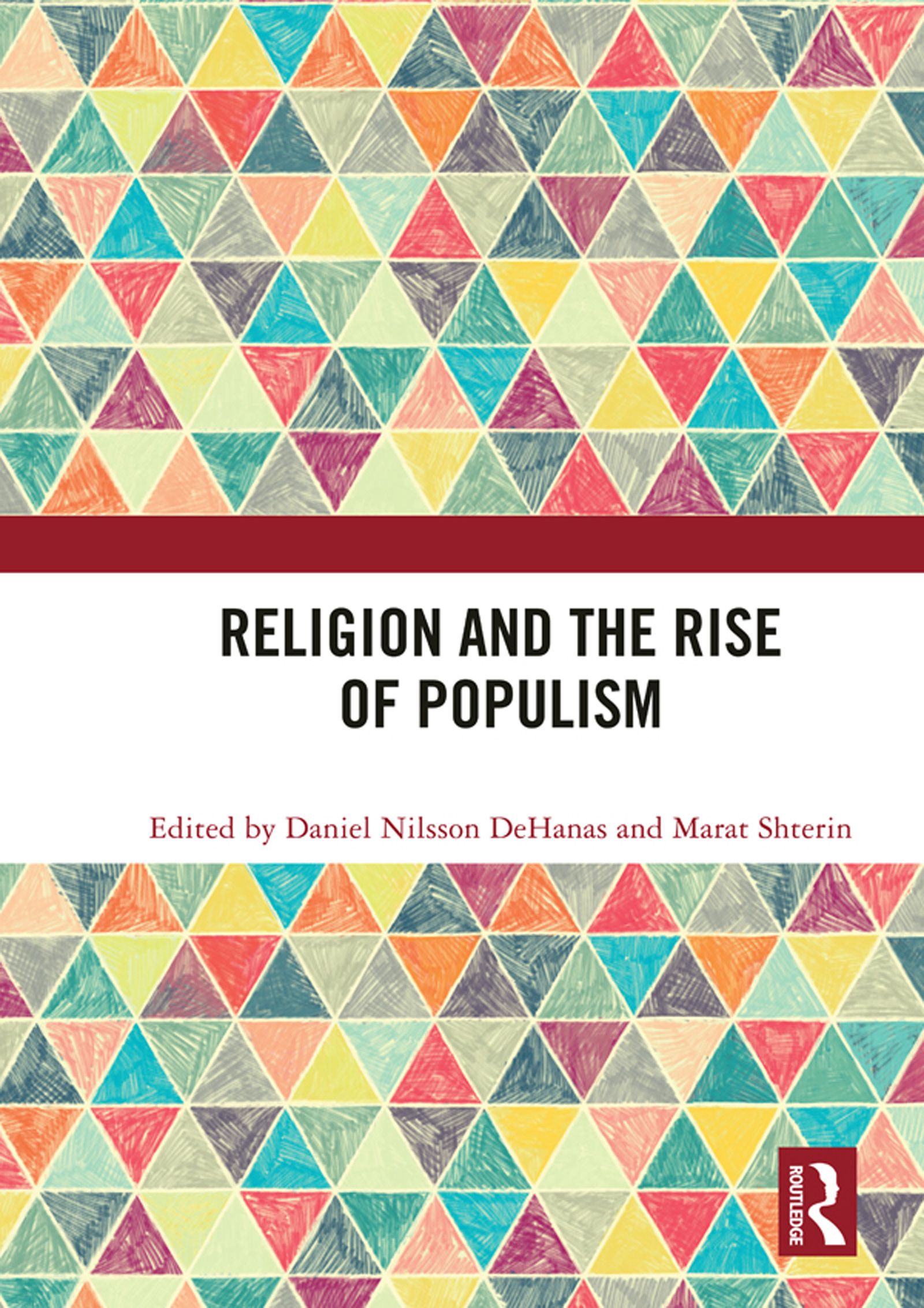
Religion and the Rise of Populism Populism is on the rise around the world. Since 2016, with the US presidential election and the Brexit debate in the UK, populism has taken a central place in global discussions on democracy. This book aims to correct the oversight that, although religion has played a key role in populism in many countries, it has been curiously neglected in recent academic debates. The authors use case studies from around the world to provide global insights into this issue. The first part of the book focuses on the West, with authors exploring the important role of Anglican voters in the Brexit referendum; rural and pre-millennialist American support for Donald Trump; and the rise of political rhetoric on Muslims in Germany, Switzerland, and Austria. The book then moves beyond the West to consider leaders and political parties in Turkey, Macedonia, Greece, Kyrgyzstan, and Kazakhstan. The authors consider varied populist types, from more established ‘ruling populists’ to young upstart movements. This wide-ranging volume redefines the concept of populism as a political style that sets a ‘sacred people’ apart from its enemies, providing a timely yet grounded account that will stimulate further research and public debate. It was originally published as a special issue of the journal Religion, State & Society. POLITICAL SCIENCE,General
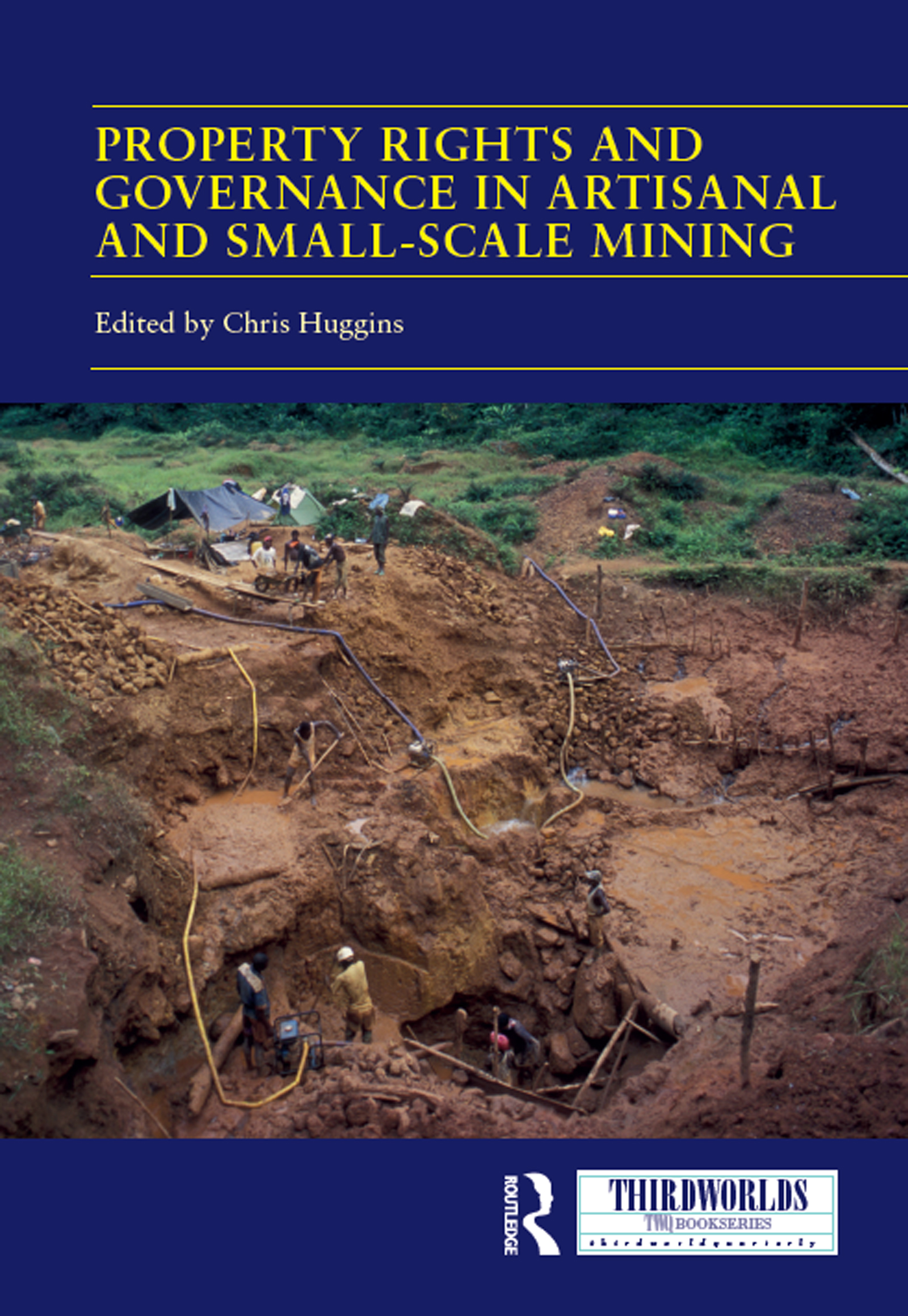
Property Rights and Governance in Artisanal and Small-Scale Mining Disputes and dispossession of property rights in the mining sector are causes of injustice, violence, and forced resettlement around the world. This comprehensive volume examines mining, particularly what is often called ‘Artisanal and Small-Scale Mining’, from a perspective of governance and rights. It focuses on rights to land, natural resources, and other forms of material ‘property’. Many projects, policies, and laws targeting artisanal and small-scale mining are embedded in problematic conceptual and institutional frameworks that implicitly stigmatise and discipline artisanal and small-scale miners. This collection takes a critical look at notions of property to destabilise some of these frameworks. The chapters in this book are notable for their recognition of the agency of artisanal miners and ‘local communities’ within the uneven hierarchies in which they are embedded, and their acknowledgement of the difficulties of state regulation of such a complex set of issues. The authors use a variety of theoretical tools, engaging with political economy, political ecology, classical economic theory, and socio-cultural concepts derived from ethnographic methods. This book includes insightful case studies from Colombia, Democratic Republic of Congo, Ghana, Mongolia, South Africa, and Zambia, and is an important resource for academics, development practitioners, and policy-makers. It was originally published online as a special issue of Third World Thematics. POLITICAL SCIENCE,General
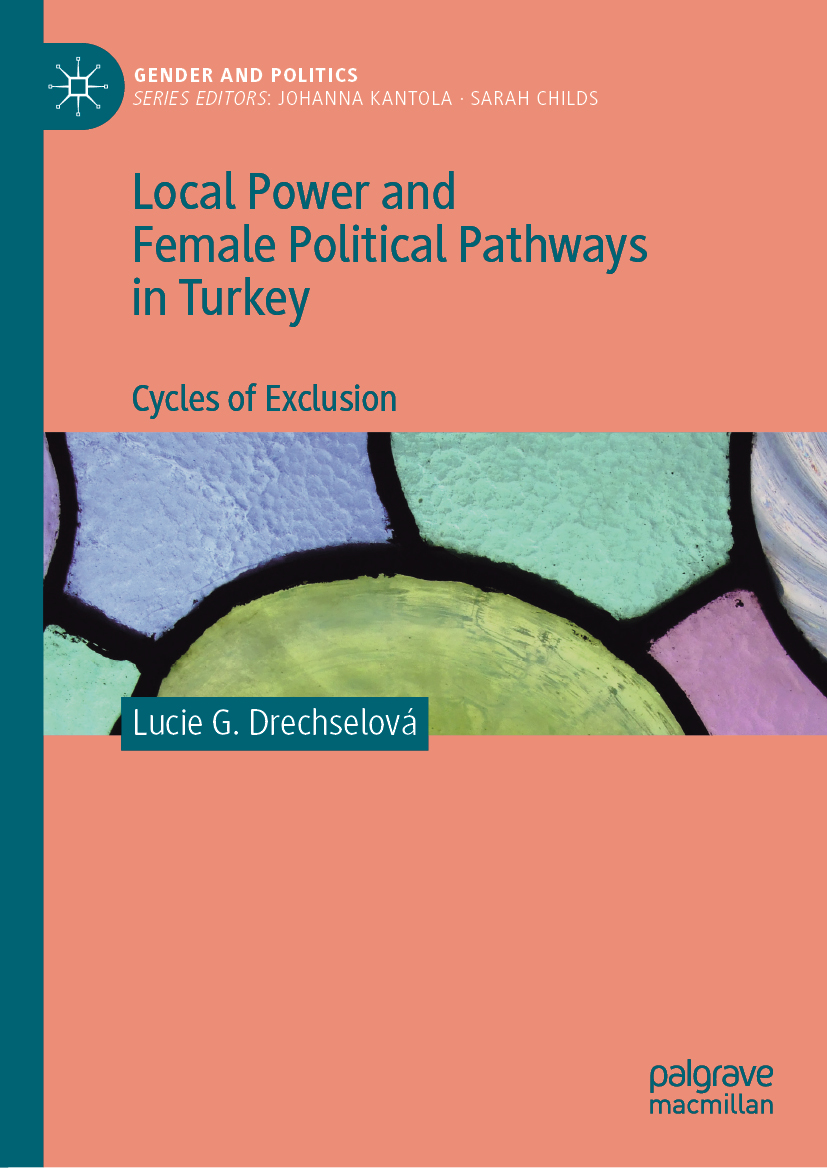
Local Power and Female Political Pathways in Turkey This book explores the “Turkish paradox†– women’s lower representation in local politics than in parliament. By analyzing life stories of 200 female municipal councilors and party representatives, it offers a comprehensive assessment of what makes local politics in Turkey particularly inaccessible to women. It places women’s pathways within the cycles of exclusion, starting by political socialization, going through the candidate recruitment process and continuing after the election. The research presented here brings together gender studies and political sociology and offers novel applications of concepts including intersectionality and biographical availability. It covers all major political parties and diverse local configurations in Turkey, and reveals political strategies of women in conservative parties as well as the reasons behind the exceptionally high representation of women within the pro-Kurdish political parties. The book further sheds some light on the intricate relationship between women’s political activity and regime change in the context of democratic backsliding. POLITICAL SCIENCE,General

Sovereignty and Illicit Social Order Contesting conventional assumptions of the modern nation-state, this book challenges us to rethink the segmentation of the political realm and its underlying economic and social processes. Cognizant of the historical context of systemic change, Lilyblad reconstructs how illicit social order arises from agonistic competition over territory, authority, and institutions. Immersive empirical investigation traces this bottom-up process in local conflict zones, detailing how spontaneous configurations of violence, socioeconomic resources, and legitimacy transcend the divide between public and private. Ultimately, the analytical vantage of global governance assesses the sobering implications for sovereignty to more accurately reflect the world we have, not the one we may want. By showing how these inherently local illicit social orders develop apart from – not below – the state within a global anarchic society, this book will be of interest to a wide range of scholars, including political scientists, economists, sociologists, geographers, as well as researchers in interdisciplinary fields such as International Development, International Political Economy, and Global Governance. POLITICAL SCIENCE,General
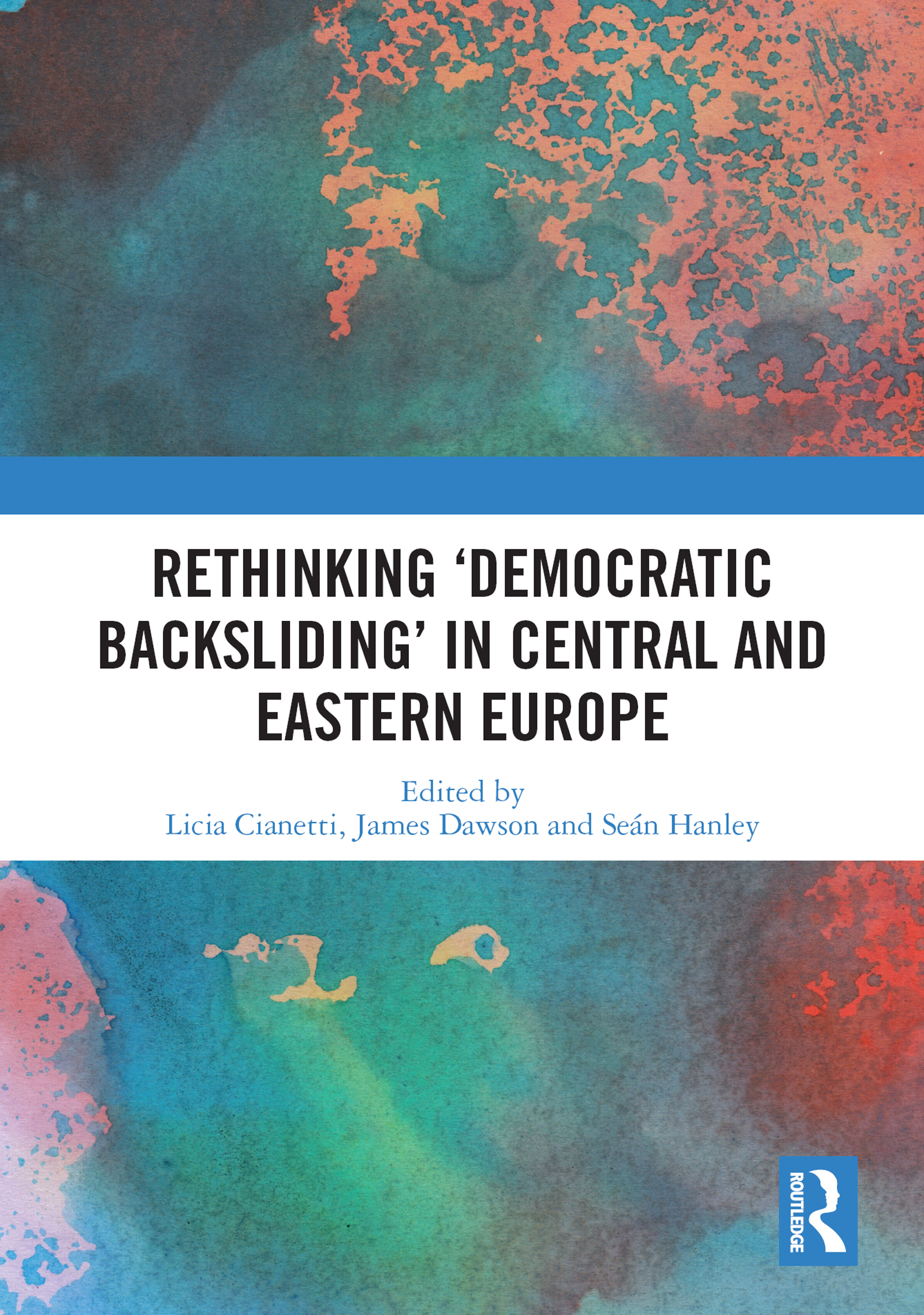
Rethinking 'Democratic Backsliding' in Central and Eastern Europe This book seeks to inject fresh thinking into the debate on democratic deterioration in Central and Eastern Europe (CEE), viewing ‘democratic backsliding’ through the prism of a range of cases beyond Hungary and Poland, to redress the imbalance in current scholarship. Over the past decade a consensus has emerged that democracy in CEE is sharply deteriorating, perhaps even ‘backsliding’ into new forms of authoritarianism. Debate has, however, so far focused disproportionately on the two most dramatic and surprising cases: Hungary and Poland. This book reflects on the ‘backsliding’ debate through the experience of CEE countries such as the Czech Republic, Bulgaria, Latvia, and Estonia; as well as neighbouring post-communist regions such as the Western Balkans and former Soviet Union (cases such as Moldova and Ukraine), whose patterns of failing or partial democratisation may be newly instructive for analysing the development of CEE. Contributors present less frequently considered perspectives on ‘democratic backsliding’ in the CEE region, such as the role of oligarchisation and wealth concentration; the potential of ethnographical approaches to democracy evaluation; the trade-offs between democratic quality and democratic stability; and the long-term interplay between social movements, state-building, and democratisation. This book was originally published as a special issue of East European Politics. POLITICAL SCIENCE,General

The Proscription of Terrorist Organisations Powers to outlaw or proscribe terrorist organisations have become cornerstones of global counter-terrorism regimes. In this comprehensive volume, an international group of leading scholars reflect on the array of proscription regimes found around the world, using a range of methodological, theoretical and disciplinary perspectives from Political Science, International Relations, Law, Sociology and Criminology. These perspectives consider how domestic political and legal institutions intersect with and transform the use of proscription in countering terrorism and beyond. The chapters advance a range of critical perspectives on proscription laws, processes and outcomes, drawing from a global range of cases including Australia, Canada, the EU, Spain, Sri Lanka, Turkey, the UK and the USA. Using single and comparative cases, the authors emphasise the impacts of proscription on freedoms of speech and association, dissent, political action and reconciliation. The chapters demonstrate the manifold consequences for diasporas and minorities, especially those communities linked to struggles overseas against oppressive regimes, and stress the significance of language and other symbolic practices in the justification and extension of proscription powers. The volume concludes with an in-depth interview on the blacklisting of terror groups with the former U.S. Director of National Intelligence, James Clapper. This book was originally published as a special issue of the journal Terrorism and Political Violence. POLITICAL SCIENCE,General
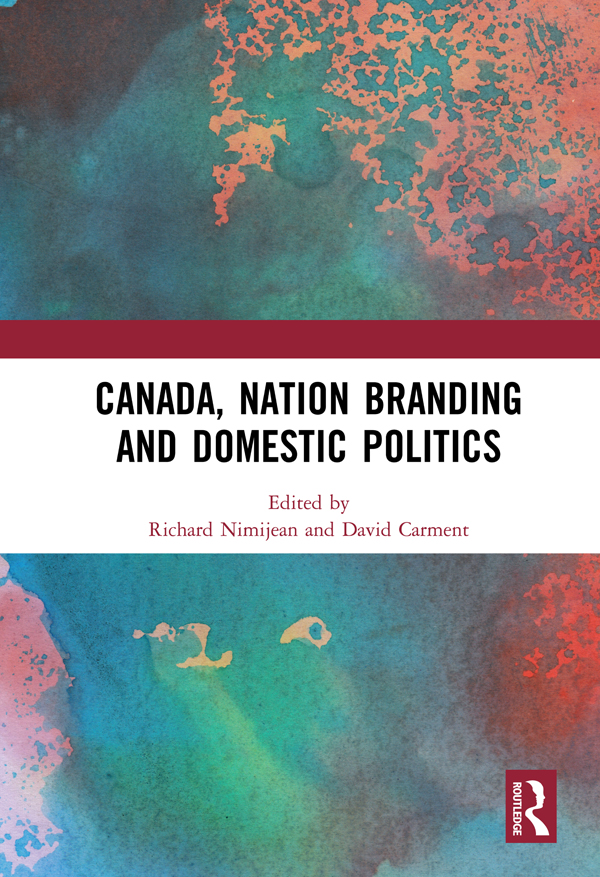
Canada, Nation Branding and Domestic Politics After his Liberal Party’s surprise victory in the 2015 federal Canadian election, Justin Trudeau declared that "Canada was back" on the world stage. This comprehensive volume highlights issues in the relationship between articulated visions of Canada as a global actor, nation branding and domestic politics, noting the dangers of the politicization of the branding of Canada. It also provides the political context for thinking about ‘Brand Canada’ in the Trudeau era. The authors explore the Trudeau government’s embrace of political branding and how it plays out in key areas central to the brand, including: Canada’s relations with Indigenous peoples; social media and digital diplomacy; and the importance of the Arctic region for Canada’s brand, even though it is often ignored by politicians and policymakers. The book asks whether the Trudeau government has lived up to its claim that Canada is back, and highlights the challenges that emerge when governments provide optimistic visions for meaningful transformation, but then do not end up leading meaningful change. This book will be of great interest to students and scholars of political science, particularly those with a focus on Canada. It was originally published as a special issue of Canadian Foreign Policy Journal. POLITICAL SCIENCE,General
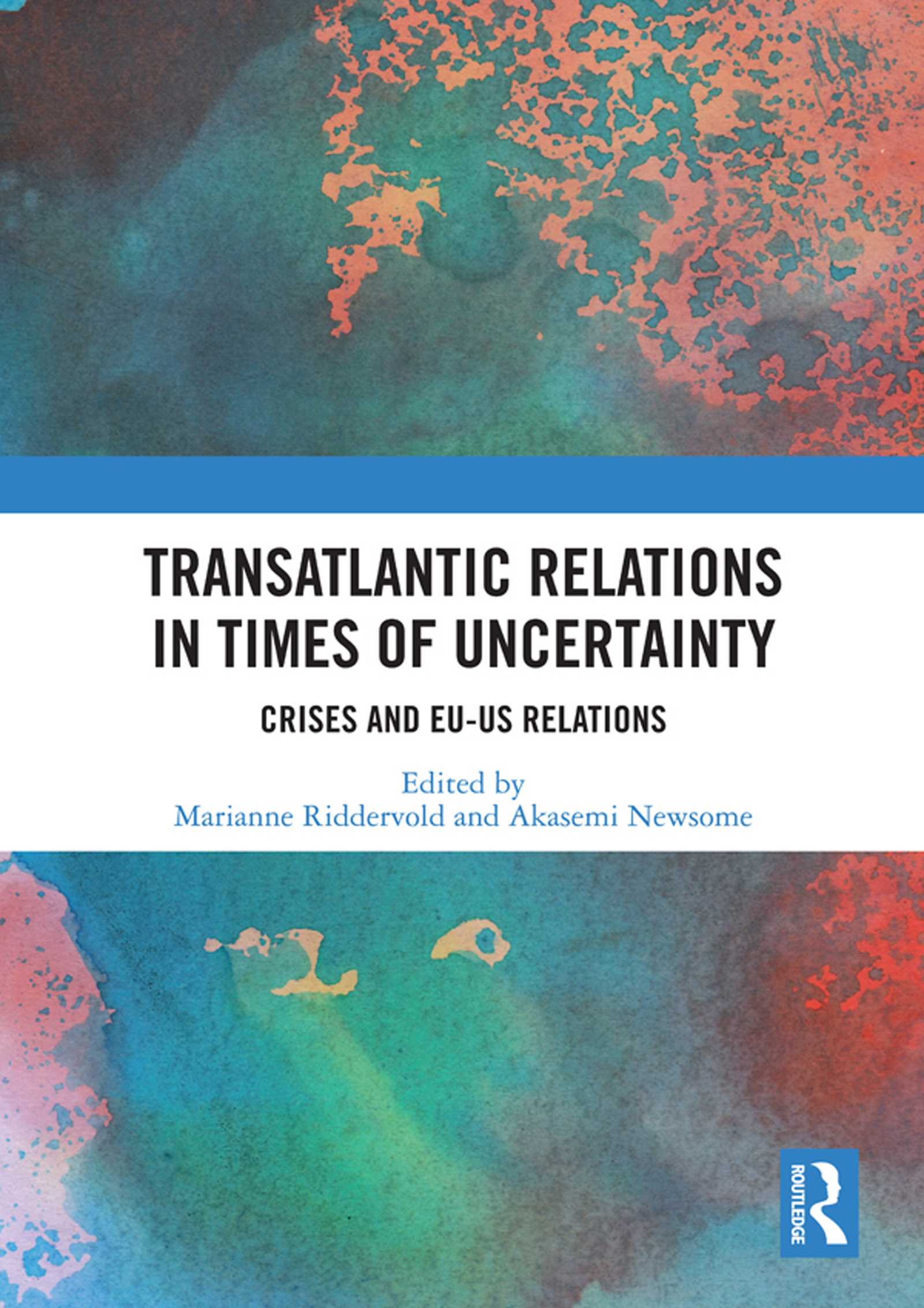
Transatlantic Relations in Times of Uncertainty Ties between the United States (US) and the European Union (EU) rival those between any other pair of international actors. After all, no other regions of the world are as closely connected in economics, security and politics as Europe and the US. This comprehensive volume makes conceptual progress and empirical contributions in accounting for how EU-US relations have been impacted by a context of multiple EU crises alongside a parallel change in US policies. The authors find strong evidence to suggest that the transatlantic relationship is weakening. This is partly a consequence of the EU’s internal policies, as it becomes more unified and autonomous of the US in some areas, while fragmenting in others. Most importantly, it is a consequence of the two actors’ increasingly diverging perspectives and positions on international issues, institutions, norms and indeed the value of the transatlantic relationship. Although the long-term effects remain to be seen, it is likely that the cracks in the foundation of transatlantic relations will continue into the present and foreseeable future. This book was originally published as a special issue of the Journal of European Integration. POLITICAL SCIENCE,General
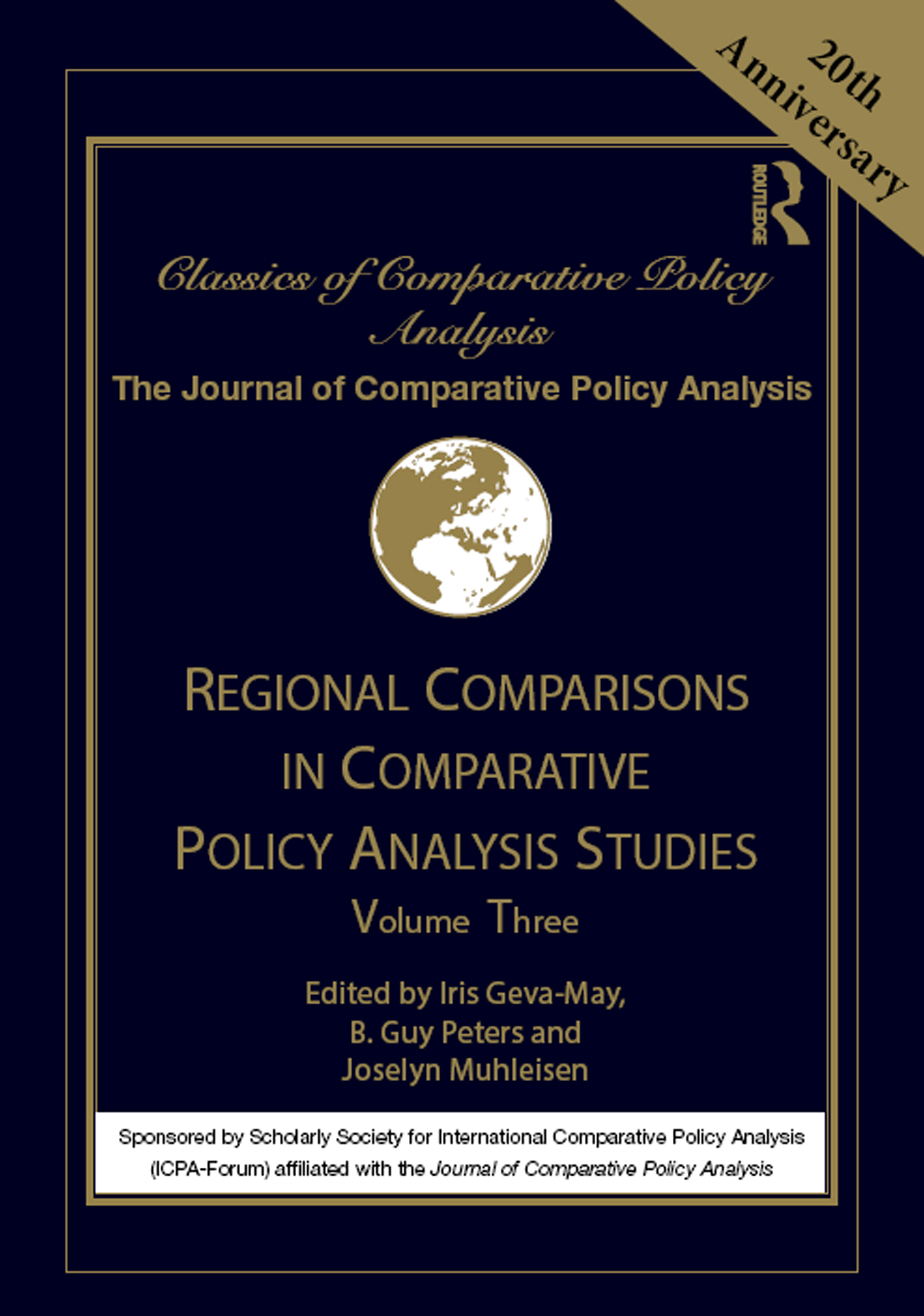
Regional Comparisons in Comparative Policy Analysis Studies Volume Three of the Classics of Comparative Policy Analysis, contains chapters concerned with "Regional Comparisons and Policy Analysis" – one of the most prevailing approaches in comparative public policy. Through the prism of inter-jurisdiction comparisons of similarities and variations, they address comparisons in specific policy sectors, governance or institutional constructs, and political regimes. The foci are, nevertheless, on those comparisons between countries or regions, which help to lesson-draw by identifying and understanding the variation in policy analysis and policy making that exists within or across regions. One benefit of regional comparisons is that it often allows studies to hold constant many variables, ranging from colonial legacy to federal systems, or from language to specific traditions, and more effectively isolate dependent variables. Regional organizations like the Organization for Economic Co-operation and Development (OECD) or European Union are also considered as catalysts for regional policy approaches and harmonization, and occupy a major role in this volume. The chapters address a broad and diverse number of countries and geographical areas: Latin America, North America, East Asia, Southeast Asia, Southern Africa, the Baltic states, the Nordic states, Western Europe, Central Europe, Eastern Europe, and Europe as a whole. "Regional Comparisons and Policy Analysis" will be of great interest to scholars and learners of public policy and social sciences, as well as to practitioners considering what can be learned or facilitated through methodologically and theoretically sound approaches. The chapters were originally published as articles in the Journal of Comparative Policy Analysis which in the last two decades has pioneered the development of comparative public policy. The volume is part of a four-volume series, the Classics of Comparative Policy Analysis including Theories and Methods, Institutions and Governance, Regional Comparisons, and Policy Sectors. Each volume showcases a different new chapter comparing domains of study interrelated with comparative public policy: political science, public administration, governance and policy design, authored by the JCPA co-editors Giliberto Capano, Iris Geva-May, Michael Howlett, Leslie A. Pal and B. Guy Peters. POLITICAL SCIENCE,General
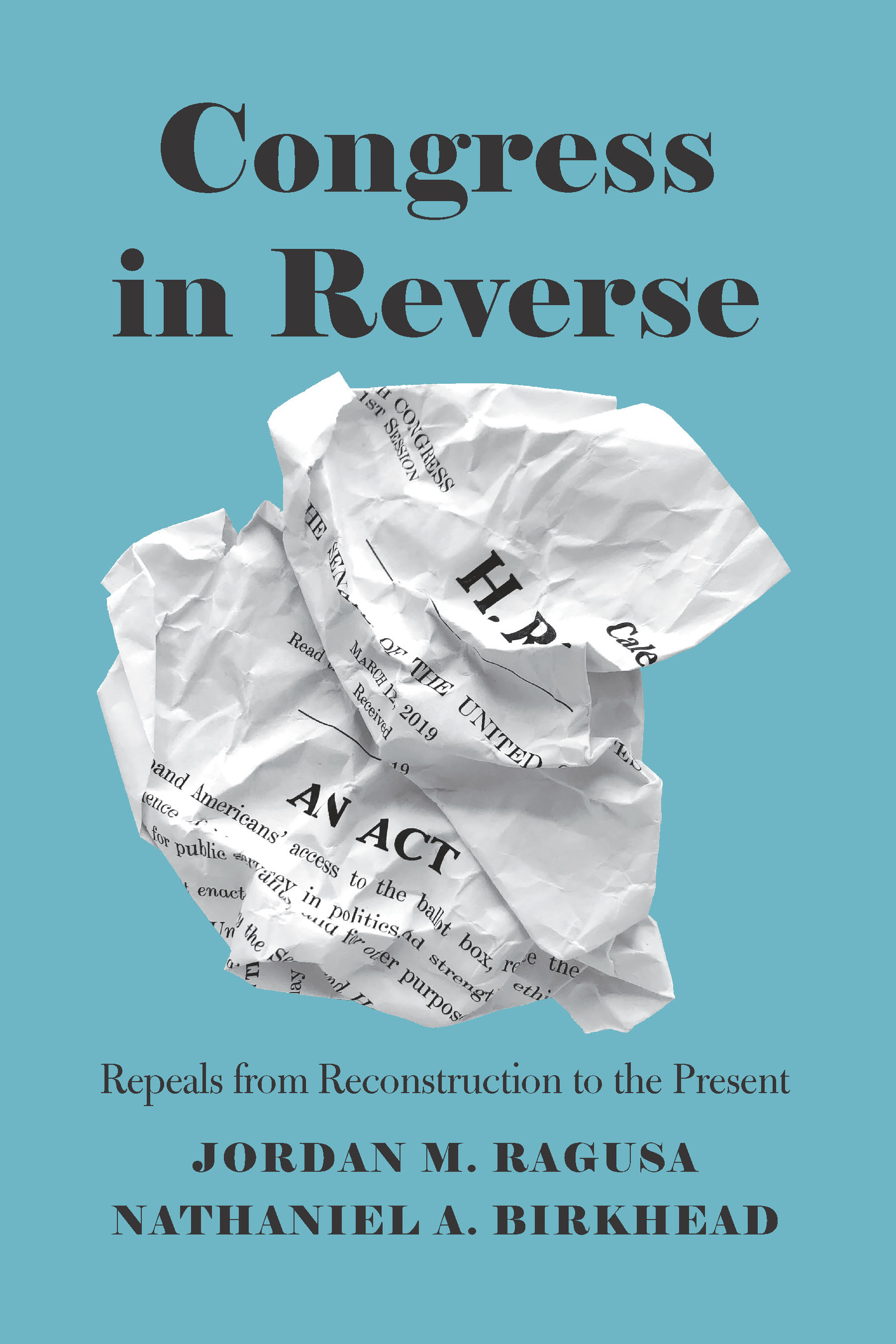
Congress in Reverse After years of divided government, countless Republicans campaigned on a promise to repeal the Affordable Care Act, better known as Obamacare. Yet when they took control of both chambers of Congress and the White House in 2017—after six years that included more than fifty symbolic votes and innumerable pledges—they failed to repeal the bulk of the law. Pundits were shocked, and observers and political scientists alike were stuck looking for an explanation. What made Obamacare so hard to repeal? And in a larger sense: What explains why some laws are repealed, and yet others endure in spite of considerable efforts? Are repeals different from law-making or do they mirror one another? Why are repeals more likely at some times than others? What theories of legislative behavior and policymaking explain when repeals happen? Congress in Reverse is the first book to attempt to answer these questions. Jordan M. Ragusa and Nathaniel A. Birkhead examine when and why existing statutes are successfully “undone,†arguing that repeals are most common when the parties are united on the issue—which was not the case when it came to Obamacare for the Republican Party—and the majority party wins control of Congress after a long stint in the minority. By shifting focus from the making of laws to their un-making, Congress in Reverse opens up a new arena for studying legislative activity in Congress. POLITICAL SCIENCE,General

Unintended Consequences of EU External Action This book offers a conceptualisation of unintended consequences and addresses a set of common research questions, highlighting the nature (what), the causes (why), and the modes of management (how) of unintended consequences of the European Union’s (EU) external action. The chapters in the book engage with conceptual and empirical dimensions of the topic, as well as scholarly and policy implications thereof. They do so by looking at EU external action across various policy domains (including trade, migration, development, state-building, democracy promotion, and rule of law reform) and geographic areas (including the USA, Russia, the Western Balkans, the southern and eastern European neighbourhood, and Africa). The book contributes to the study of the EU as an international actor by broadening the notion of its impact abroad to include the unintended consequences of its (in)actions and by shedding new light on the conceptual paradigms that explain EU external action. This book fills the gap in IR and EU scholarship concerning unintended consequences in an international context and will be of interest to anyone studying this important phenomenon. It was originally published as a special issue of The International Spectator (Italian Journal of International Affairs). Chapters 1, 3, 7, 8 and 9 are available Open Access at https://www.routledge.com/products/9780367346492. POLITICAL SCIENCE,General

The Government of France Originally published in 1919. French institutions of today, considered as a whole, form a composite building on which every new regime for the last hundred years has left its mark. The foundation is provided by the social, legal, judicial and administrative system of the Napoleonic Empire, which was crowned in 1875 by the corner-stone of parliamentary democracy. Many other features has been left by other regimes; thus France owes her general principles of common law and her administrative divisions to the Revolution. POLITICAL SCIENCE,General
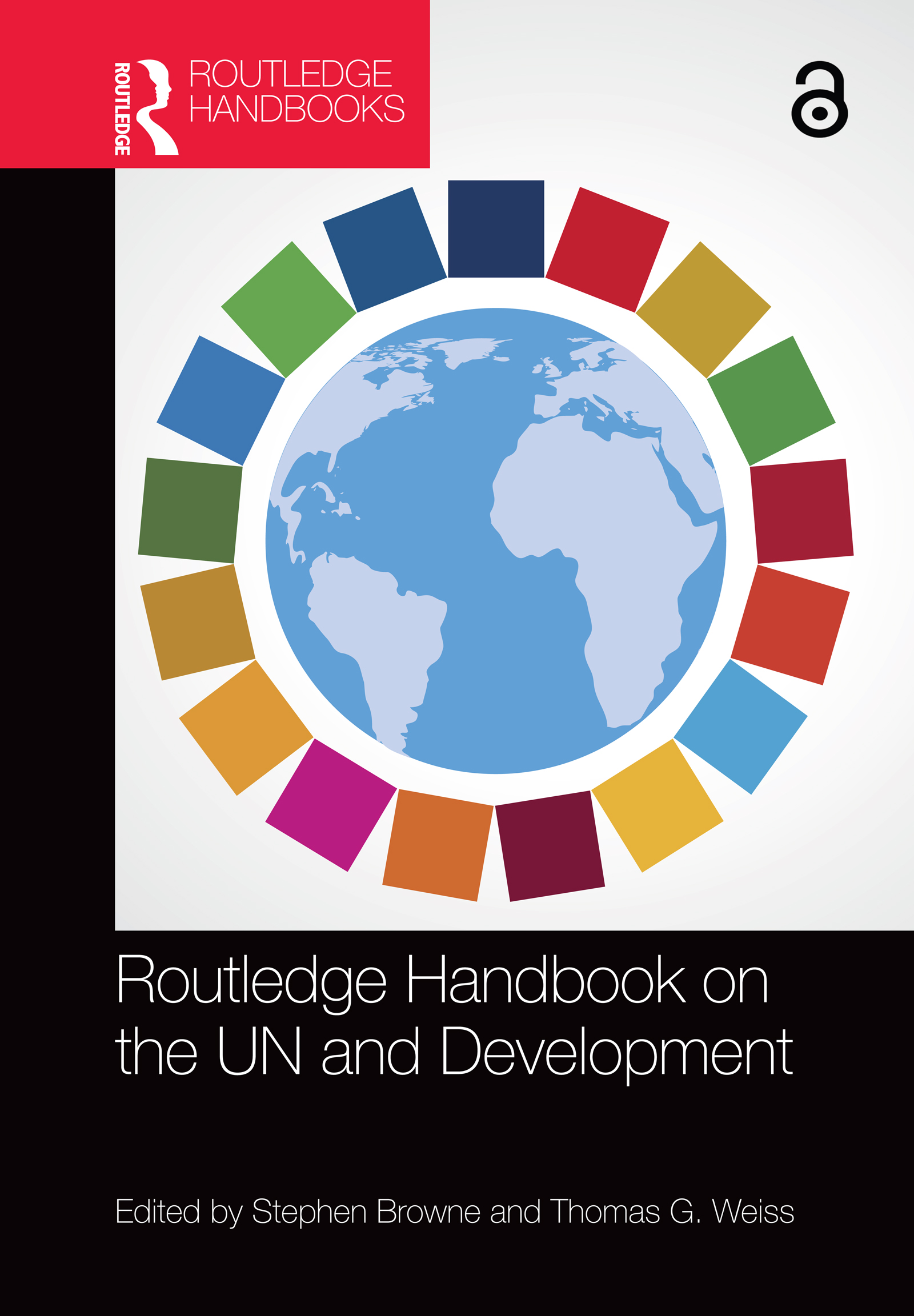
Routledge Handbook on the UN and Development International commissions, academics, practitioners, and the media have long been critical of the UN’s development efforts as disjointed and not fit for purpose; yet the organization has been an essential contributor to progress and peacebuilding. This handbook explores the activities of the UN development system (UNDS), the largest operational pillar of the organization and arguably the arena in which its ideational endeavors have made the biggest contribution to thinking and standards. Contributions focus on the role of the UNDS in sustainable social, economic, and environmental development, describing how the UNDS interacts with the other major functions of the UN system, and how it performs operationally in the context of the new 2030 development agenda focused on the 17 Sustainable Development Goals (SDGs). The volume is divided into three sections: Realizing the SDGs: opportunities and challenges; Resources, partnerships, and management; and Imagining the future of the UN in development. Comprised of chapters by knowledgeable and authoritative UN experts, this book provides cutting-edge and up-to-date research on the strengths and weaknesses of the UNDS, with each chapter focusing on different operational and ideational aspects. Chapter 11 of this book is freely available as a downloadable Open Access PDF under a Creative Commons Attribution-Non Commercial-No Derivatives 4.0 license at https://tandfbis.s3-us-west-2.amazonaws.com/rt-files/docs/Open+Access+Chapters/9780367186852_oachapter11.pdf POLITICAL SCIENCE,General
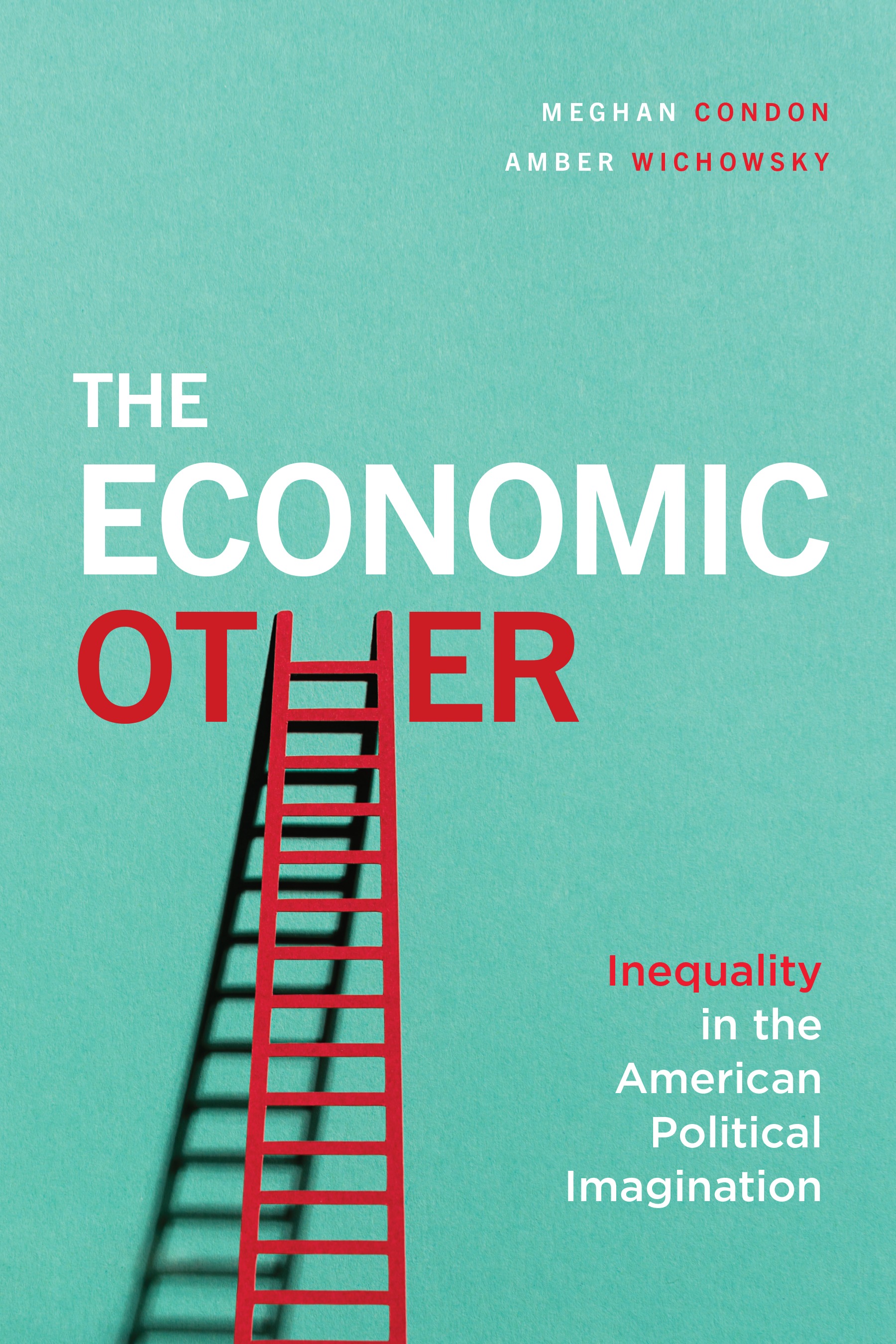
The Economic Other Economic inequality is at a record high in the United States, but public demand for redistribution is not rising with it. Meghan Condon and Amber Wichowsky show that this paradox and other mysteries about class and US politics can be solved through a focus on social comparison. Powerful currents compete to propel attention up or down—toward the rich or the poor—pulling politics along in the wake. Through an astute blend of experiments, surveys, and descriptions people offer in their own words, The Economic Other reveals that when less-advantaged Americans compare with the rich, they become more accurate about their own status and want more from government. But American society is structured to prevent upward comparison. In an increasingly divided, anxious nation, opportunities to interact with the country’s richest are shrinking, and people prefer to compare to those below to feel secure. Even when comparison with the rich does occur, many lose confidence in their power to effect change. Laying bare how social comparisons drive political attitudes, The Economic Other is an essential look at the stubborn plight of inequality and the measures needed to solve it. POLITICAL SCIENCE,General
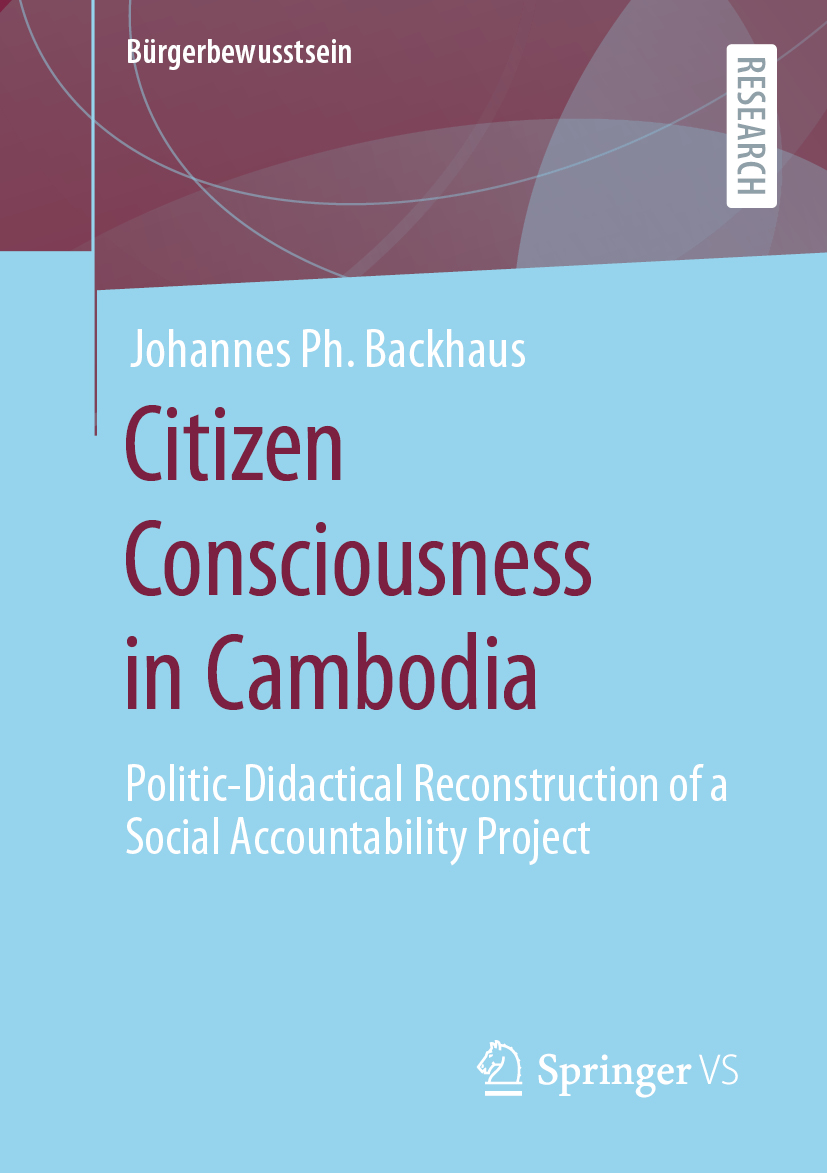
Citizen Consciousness in Cambodia Johannes Ph. Backhaus applies the Model of Education Reconstruction (MER) to the context of a social accountability intervention in Cambodia. This book is not an evaluation but adopts a qualitative perspective on the learning approach applied by the researched intervention. The research found that the learning intervention does not systematically include learners’ pre-existing social knowledge. It would potentially benefit from systematically harvesting and reinforcing pre-held convictions to sustainably motivate participation. It does not address potentially sensitive topics while interviewees show a sophisticated and holistic understanding of these. Finally, there are inconsistencies between the program’s aims and objectives. In sum, the piloted approach offers pathways on how to beneficially include qualitative perspectives on similar development interventions. POLITICAL SCIENCE,General

Peacebuilding in Israeli-Palestinian Relations Focusing on peacebuilding, this book emphasizes how "grassroots" peacebuilding efforts contribute to closing the gap between the Israeli and Palestinian national communities. POLITICAL SCIENCE,General
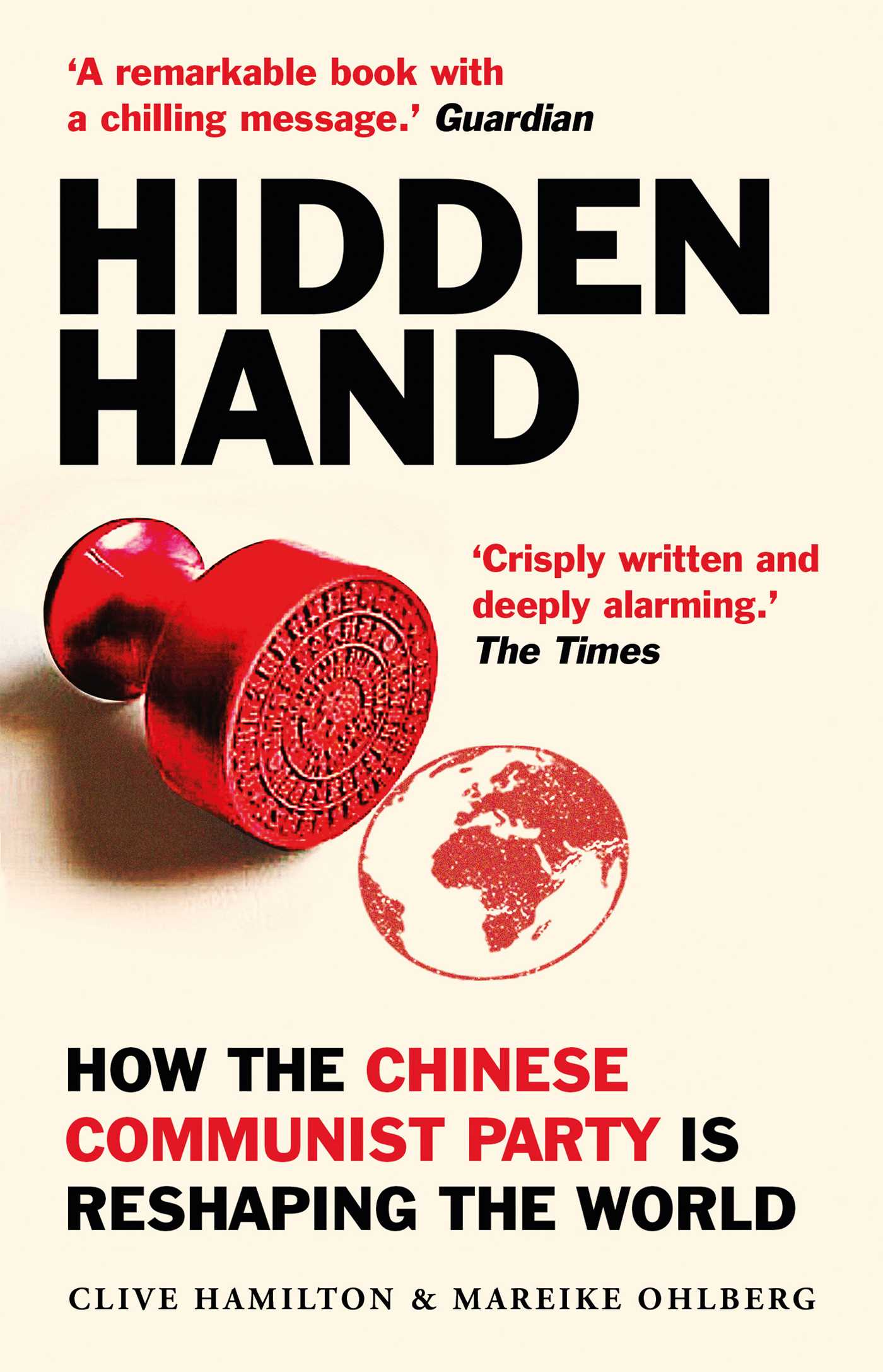
Hidden Hand 'Hidden Hand is heavily sourced, crisply written and deeply alarming.' The Times 'This is a remarkable book with a chilling message.' The Guardian The Chinese Communist Party is determined to reshape the world in its image. The party is not interested in democracy. It sees only a bitter ideological struggle with the West, dividing the world into those who can be won over, and enemies. Many political and business elites have already been lured to their corner; others are weighing up a devil’s bargain. Through its enormous economic power and covert influence operations, China is now weakening global institutions, aggressively targeting individual corporations, and threatening freedom of expression from the arts to academia. At the same time, Western security services are increasingly worried about incursions into our communications infrastructure. In a landmark study combining meticulous research with unique insights, Hidden Hand exposes the Chinese Communist Party’s global program of subversion, and the threat it poses to democracy. We have already missed too many warning signs – now it is time to wake up. POLITICAL SCIENCE,General
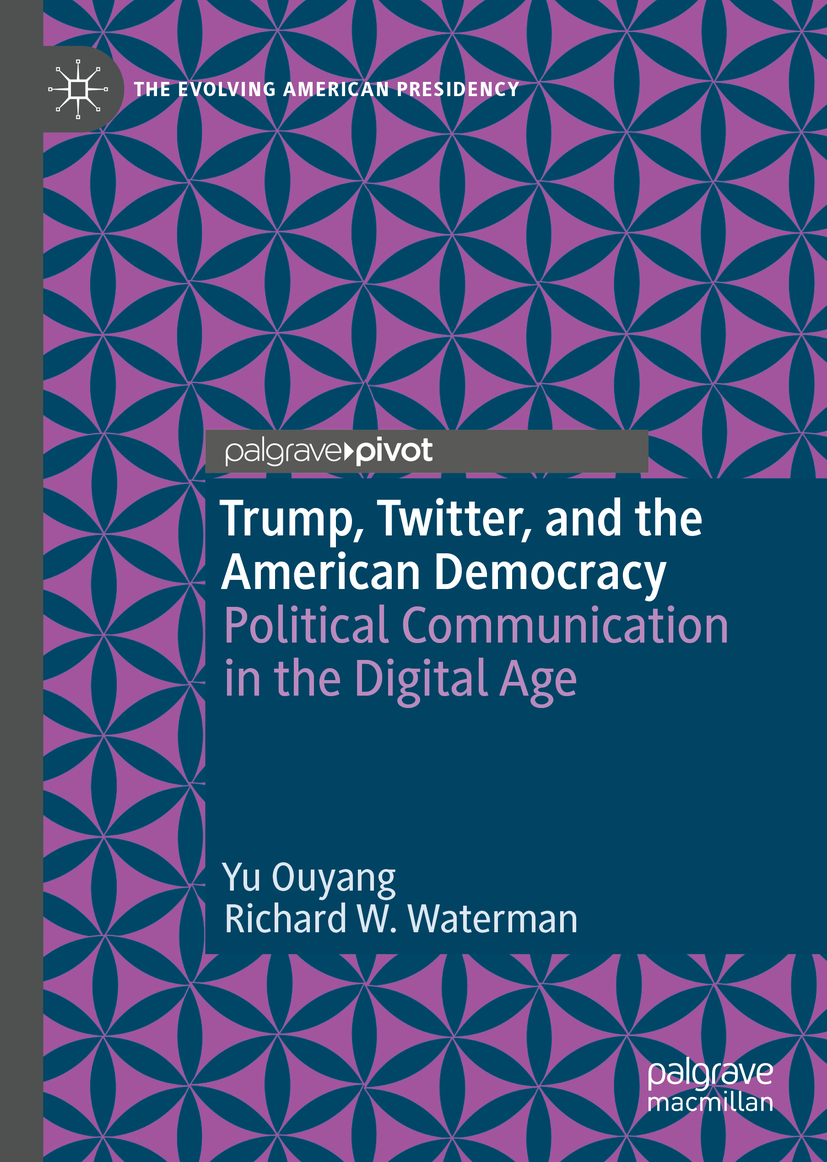
Trump, Twitter, and the American Democracy This book takes a social science approach to address two related questions: (1) what does Donald Trump say on Twitter? and (2) why? Since entering the 2016 Presidential Election, Donald Trump’s tweets have been a major part of his communications strategy with the public. While the popular media has devoted considerable attention to selected tweets, it is less clear what those selected tweets tell us about Trump the businessman, the political candidate, and, finally, the President of the United States. We argue that to fully understand Trump, we must take a more comprehensive approach to examining all of his activities on Twitter. Overall, our analysis presents a strikingly complex picture of Trump and how he uses Twitter. Not only has his pattern of tweets changed over time, we find that Trump’s use of Twitter is more deliberate than he has been given credit. Like most other politicians, Trump is strategically-minded about his presence on social media. POLITICAL SCIENCE,General
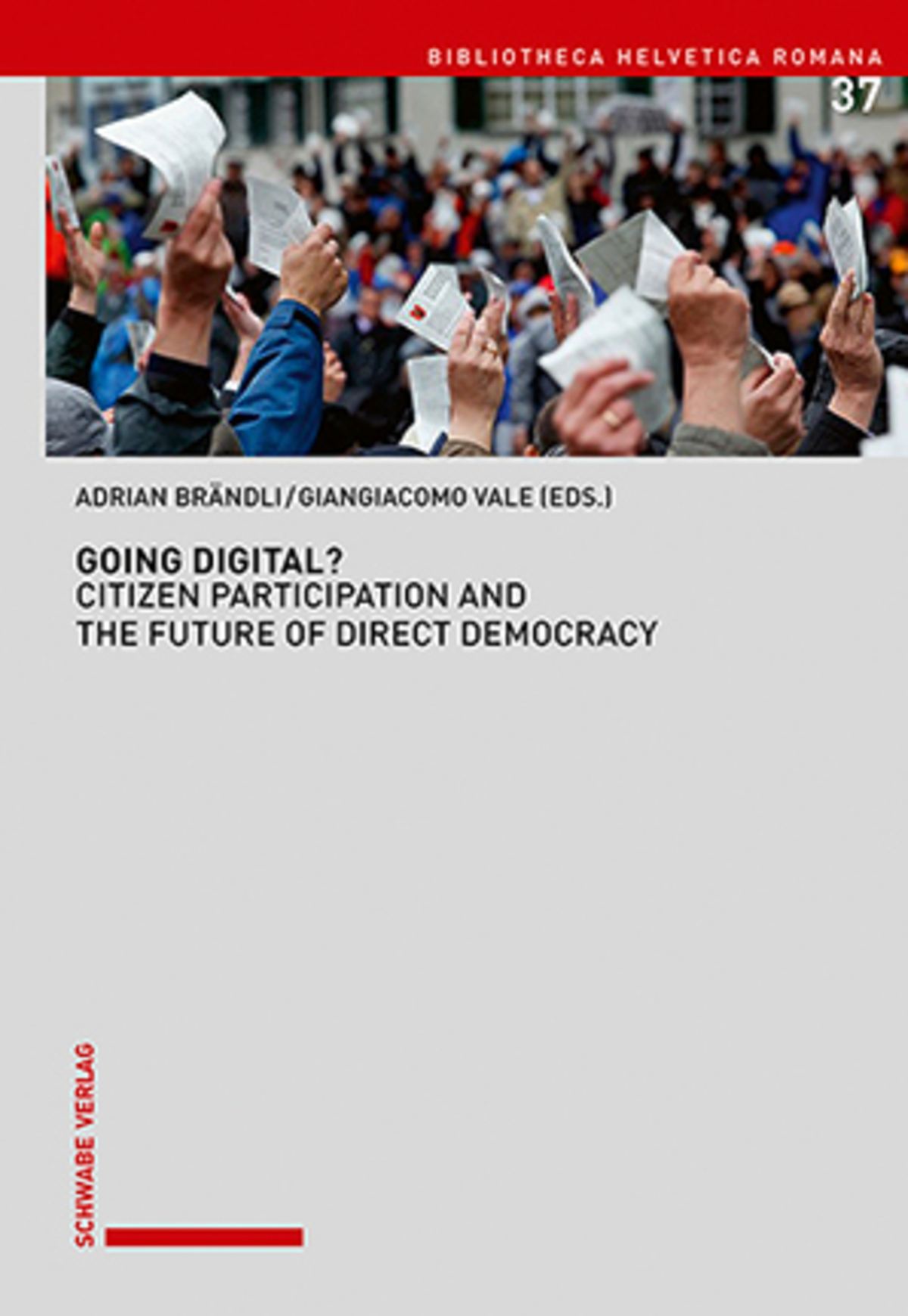
Going Digital? Do new technologies represent a turning point regarding opportunities and challenges of direct democracy? This question is at the centre of the contributions to this book. The authors especially concentrate on the political cultures of Switzerland and Italy: While Switzerland is often regarded as an exemplary case of modern direct democracy, in recent years Italy has had heated discussions about its representative institutions. This was the starting point for an international exchange across cultural, linguistic and disciplinary boundaries. POLITICAL SCIENCE,General
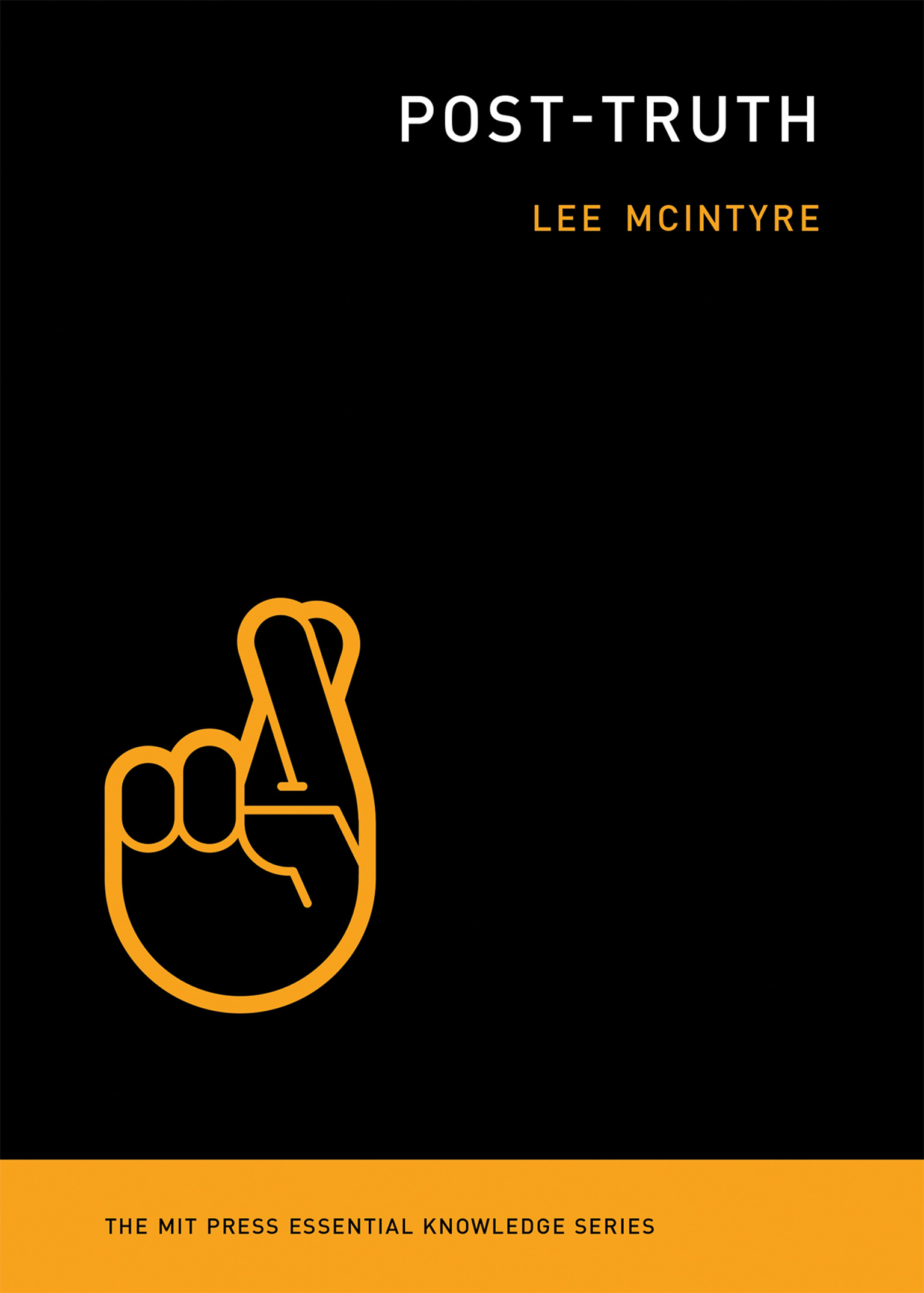
Post-Truth How we arrived in a post-truth era, when “alternative facts” replace actual facts, and feelings have more weight than evidence. Are we living in a post-truth world, where “alternative facts” replace actual facts and feelings have more weight than evidence? How did we get here? In this volume in the MIT Press Essential Knowledge series, Lee McIntyre traces the development of the post-truth phenomenon from science denial through the rise of “fake news,” from our psychological blind spots to the public's retreat into “information silos.” What, exactly, is post-truth? Is it wishful thinking, political spin, mass delusion, bold-faced lying? McIntyre analyzes recent examples—claims about inauguration crowd size, crime statistics, and the popular vote—and finds that post-truth is an assertion of ideological supremacy by which its practitioners try to compel someone to believe something regardless of the evidence. Yet post-truth didn't begin with the 2016 election; the denial of scientific facts about smoking, evolution, vaccines, and climate change offers a road map for more widespread fact denial. Add to this the wired-in cognitive biases that make us feel that our conclusions are based on good reasoning even when they are not, the decline of traditional media and the rise of social media, and the emergence of fake news as a political tool, and we have the ideal conditions for post-truth. McIntyre also argues provocatively that the right wing borrowed from postmodernism—specifically, the idea that there is no such thing as objective truth—in its attacks on science and facts. McIntyre argues that we can fight post-truth, and that the first step in fighting post-truth is to understand it. POLITICAL SCIENCE,General
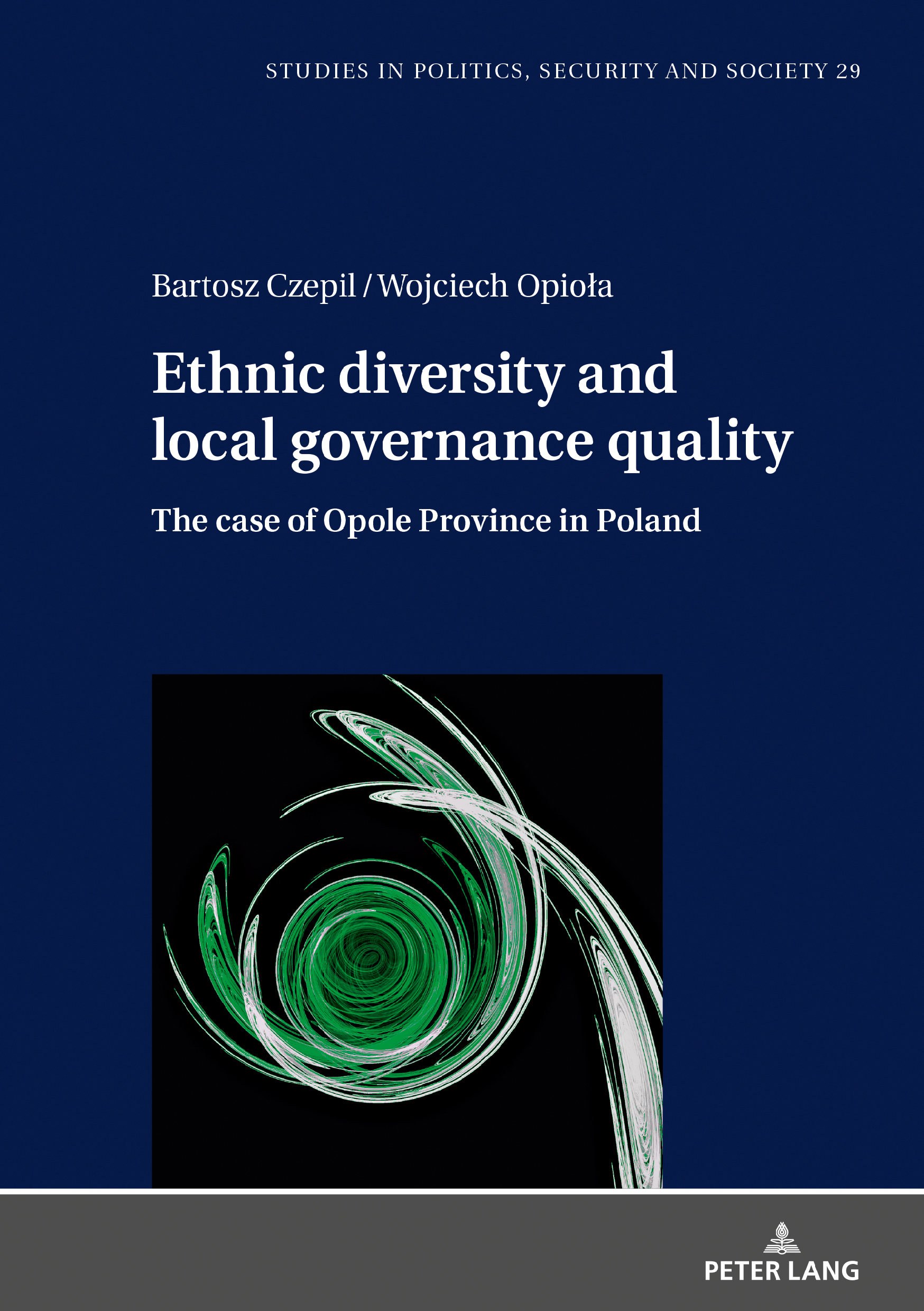
Ethnic diversity and local governance quality The book is devoted to relations between the ethnic diversity and the quality of governance at the local level. Opolskie province in Poland is a case for explaining this interdependence. Authors assumed, that the quality of governance would be higher in communes characterized by ethnic diversity. POLITICAL SCIENCE,General
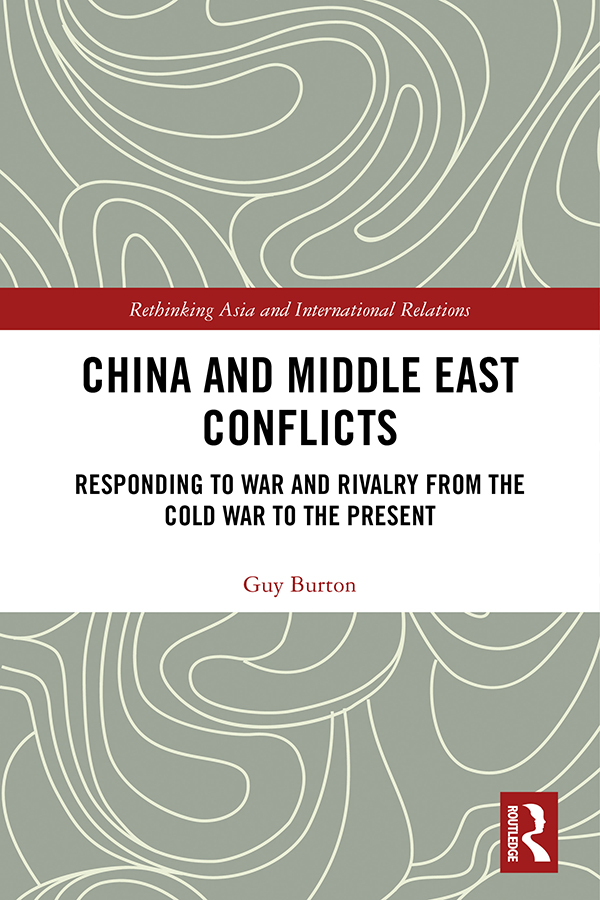
China and Middle East Conflicts How do aspiring and established rising global powers respond to conflict? Using China, the book studies its response to wars and rivalries in the Middle East from the Cold War to the present. Since the People’s Republic was established in 1949, China has long been involved in the Middle East and its conflicts, from exploiting or avoiding them to their management, containment or resolution. Using a conflict and peace studies angle, Burton adopts a broad perspective on Chinese engagement by looking at its involvement in the region’s conflicts including Israel/Palestine, Iraq before and after 2003, Sudan and the Darfur crisis, the Iranian nuclear deal, the Gulf crisis and the wars in Syria, Libya and Yemen. The book reveals how a rising global and non-Western power handles the challenges associated with both violent and nonviolent conflict and the differences between limiting and reducing violence alongside other ways to eliminate the causes of conflict and grievance. Contributing to the wider discipline of International Relations and peace and conflict studies, this book will be of interest to students and scholars of peace and conflict studies, Chinese foreign policy and the politics and international relations of the Middle East. POLITICAL SCIENCE,General
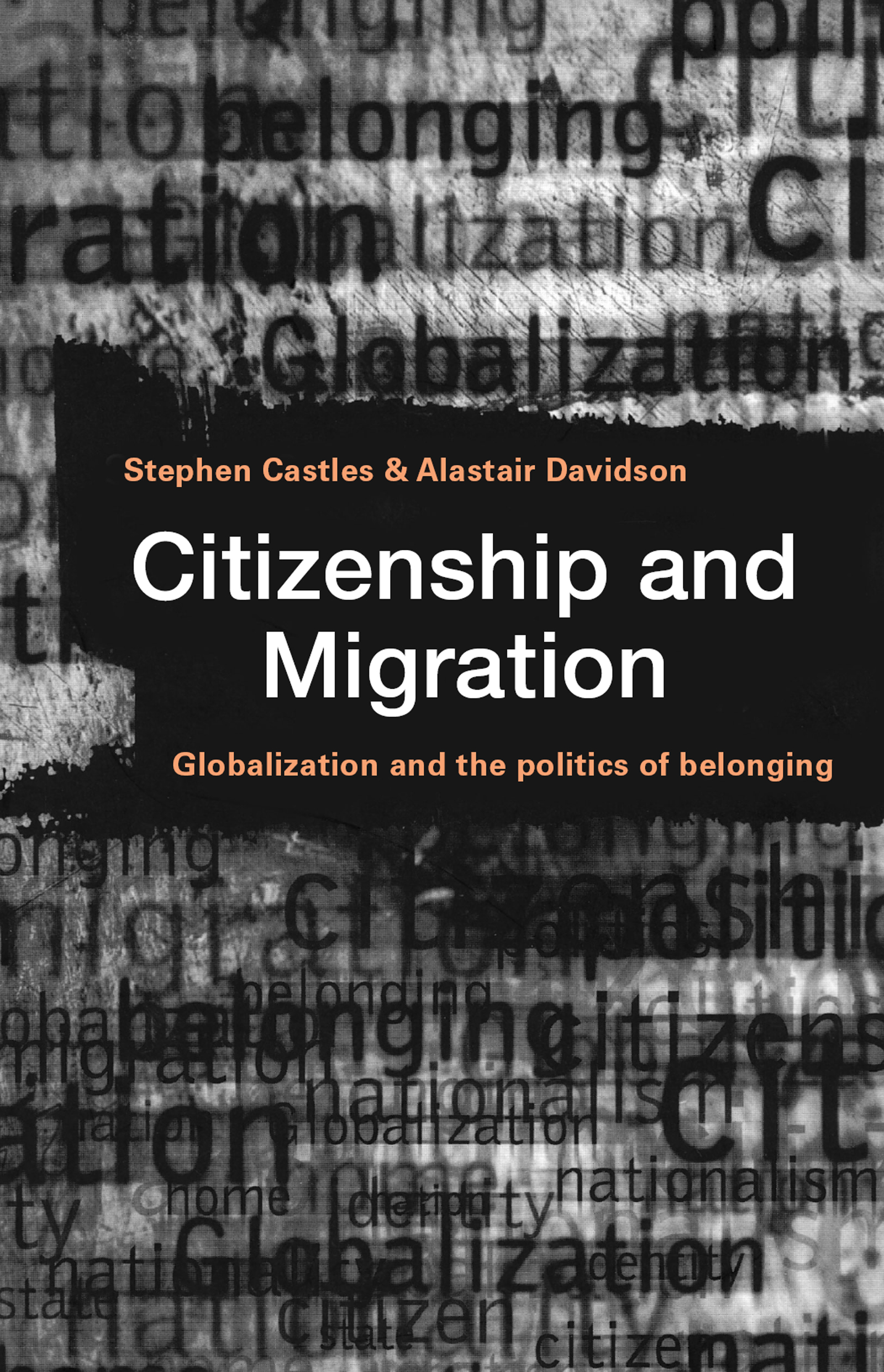
Citizenship and Migration This book argues that basing citizenship on singular and individual membership in a nation-state is no longer adequate, since the nation-state model itself is being severely eroded. It examines issues of citizenship and difference in the Asia-Pacific region. POLITICAL SCIENCE,General
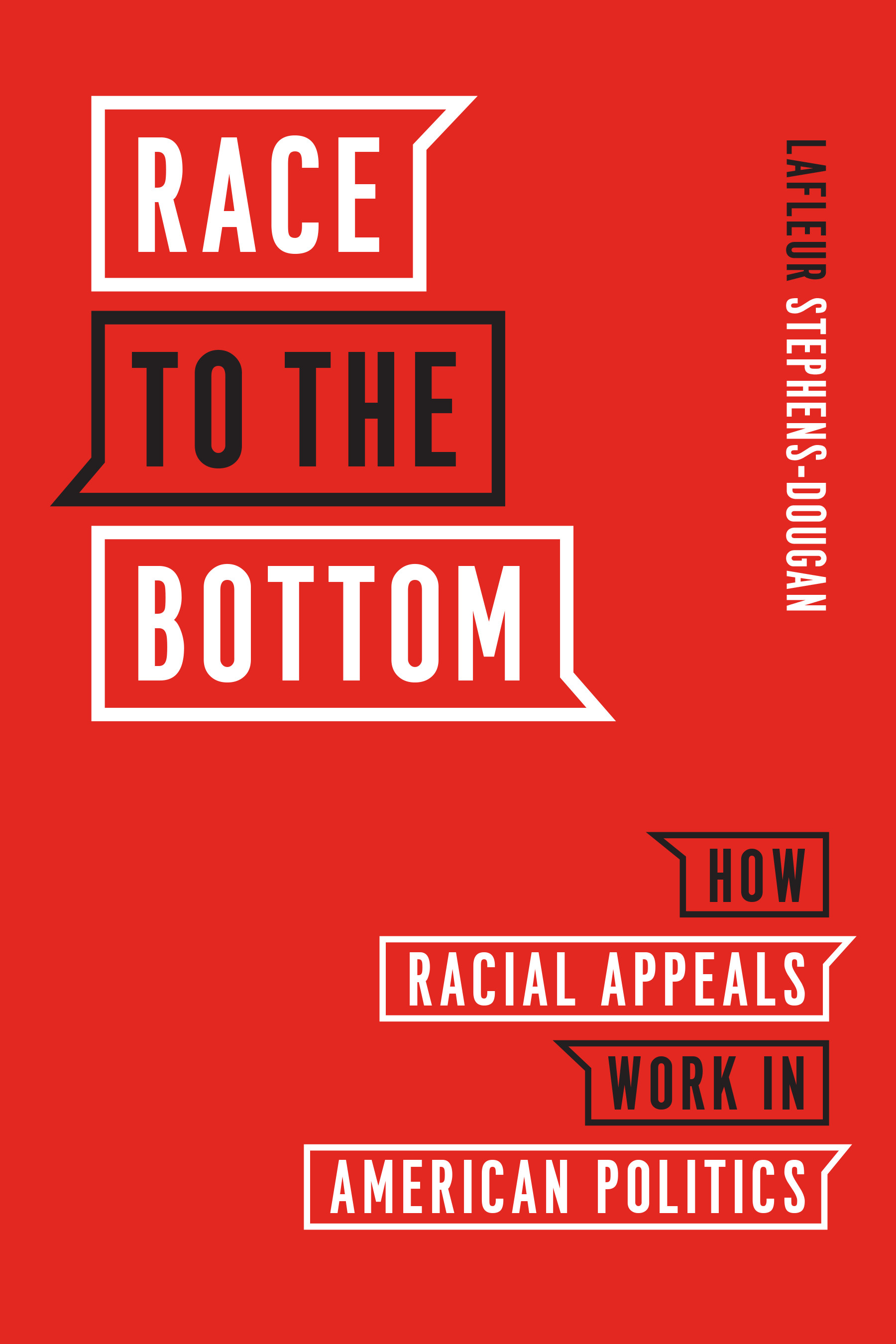
Race to the Bottom African American voters are a key demographic to the modern Democratic base, and conventional wisdom has it that there is political cost to racialized “dog whistles,†especially for Democratic candidates. However, politicians from both parties and from all racial backgrounds continually appeal to negative racial attitudes for political gain. Challenging what we think we know about race and politics, LaFleur Stephens-Dougan argues that candidates across the racial and political spectrum engage in “racial distancing,†or using negative racial appeals to communicate to racially moderate and conservative whites—the overwhelming majority of whites—that they will not disrupt the racial status quo. Race to the Bottom closely examines empirical data on racialized partisan stereotypes to show that engaging in racial distancing through political platforms that do not address the needs of nonwhite communities and charged rhetoric that targets African Americans, immigrants, and others can be politically advantageous. Racialized communication persists as a well-worn campaign strategy because it has real electoral value for both white and black politicians seeking to broaden their coalitions. Stephens-Dougan reveals that claims of racial progress have been overstated as our politicians are incentivized to employ racial prejudices at the expense of the most marginalized in our society. POLITICAL SCIENCE,General

Intersectional Decoloniality This book assesses diverse ways to think about “others†while also emphasizing the advantages of decolonial intersectionality. The author analyzes a number of struggles that emerge among Andean indigenous intellectuals, governmental projects, and International Relations scholars from the Global North. From different perspectives, actors propose and promote diverse ways to deal with “othersâ€. By focusing on the epistemic assumptions and the marginalizing effects that emerge from these constructions, the author separates four ways to think about difference, and analyzes their implications. The genealogical journey linking the chapters in this book not only examines the specificities of Bolivian discussions, but also connects this geo-historical focal point with the rest of the world, other positions concerning the problem of difference, and the broader implications of thinking about respect, action, and coexistence. To achieve this goal, the author emphasizes the potential implications of intersectional decoloniality, highlighting its relationship with discussions that engage post-colonial, decolonial, feminist, and interpretivist scholars. He demonstrates the ways in which intersectional decoloniality moves beyond some of the limitations found in other discourses, proposing a reflexive, bottom-up, intersectional, and decolonial possibility of action and ally-ship. This book is aimed primarily at students, scholars, and educated practitioners of IR, but its engagement with diverse literature, discussions of epistemic politics, and normative implications crosses boundaries of Political Science, Sociology, Gender Studies, Latin American Studies, and Anthropology. POLITICAL SCIENCE,General
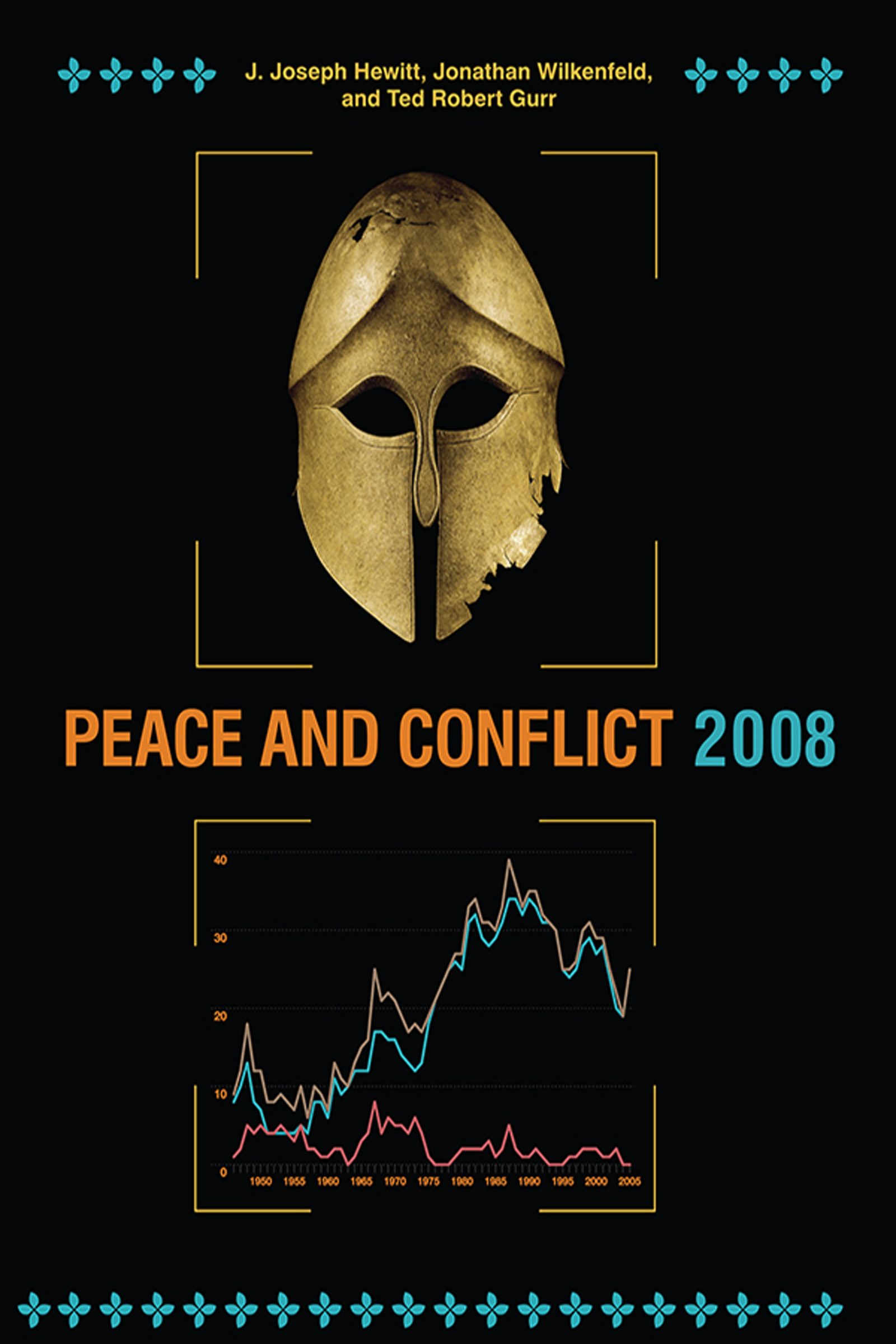
Peace and Conflict 2008 Peace and Conflict is a biennial publication that provides key data and documents trends in national and international conflicts ranging from isolated acts of terrorism to internal civil strife to full-fledged interstate war. Peace and Conflict is a large format, full-color reference including numerous graphs, tables, maps, and appendices dedicated to the visual presentation of data. Crisp narratives are highlighted with pull-quote extracts that summarize trends and major findings. POLITICAL SCIENCE,General

Gerald Ford and the Challenges of the 1970s For many Americans, Gerald Ford evokes an image of either an unelected president who abruptly pardoned his corrupt predecessor or an accident-prone klutz who failed to provide skilled leadership. In Gerald Ford and the Challenges of the 1970s, Yanek Mieczkowski reexamines Ford's two and a half years in office, showing that his presidency successfully confronted the most vexing crisis of postwar era. Viewing the 1970s primarily through the lens of economic events, Mieczkowski argues that Ford's understanding of the national economy was better than any modern president, that he oversaw a dramatic reduction of inflation, and that he attempted to solve the energy crisis with judicious policies. Throughout his presidency, Ford labored under the legacy of Watergate. Democrats scored landslide victories in the 1974 midterm elections, and within an anemic Republican Party, the right wing challenged Ford's leadership, even as pundits predicted the GOP's death. Yet Ford reinvigorated the party and fashioned a 1976 campaign strategy against Jimmy Carter that brought him from thirty points behind to a dead heat on election day. Mieczkowski draws on numerous personal interviews with former President Ford, cabinet officials, and members of the Ninety-fourth Congress, and he skillfully weaves into his discussion such 1970s cultural phenomena as the spoofs about the president on Saturday Night Live. The first major work on Ford to appear in more than a decade, Gerald Ford and the Challenges of the 1970s combines the best of biography and presidential history to paint an intriguing portrait of a president, his times, and his legacy. POLITICAL SCIENCE,General

Religion and Politics Muslim societies are struggling under the need for modernization and the drift towards Islamic fundamentalism. The balance between these two forces is struck differently in the various Muslim societies depending upon the constellation of groups as historical legacies. However, the tension is real. In this work, Jan-Erik Lane and Hamadi Redissi look at the underlying social consequences of religious beliefs to account for the political differences between major civilizations of the world against a background of the rise of modern capitalism. Offering a timely new appraisal of the political and social impact of Islam, this expanded second edition of Religion and Politics has been fully updated in line with new events and will be welcomed by political scientists and historians alike. In a readable and accessible style, this thought-provoking work raises the question of whether the tenets of Islam might be reconciled with the requirements of post-modernity. POLITICAL SCIENCE,General
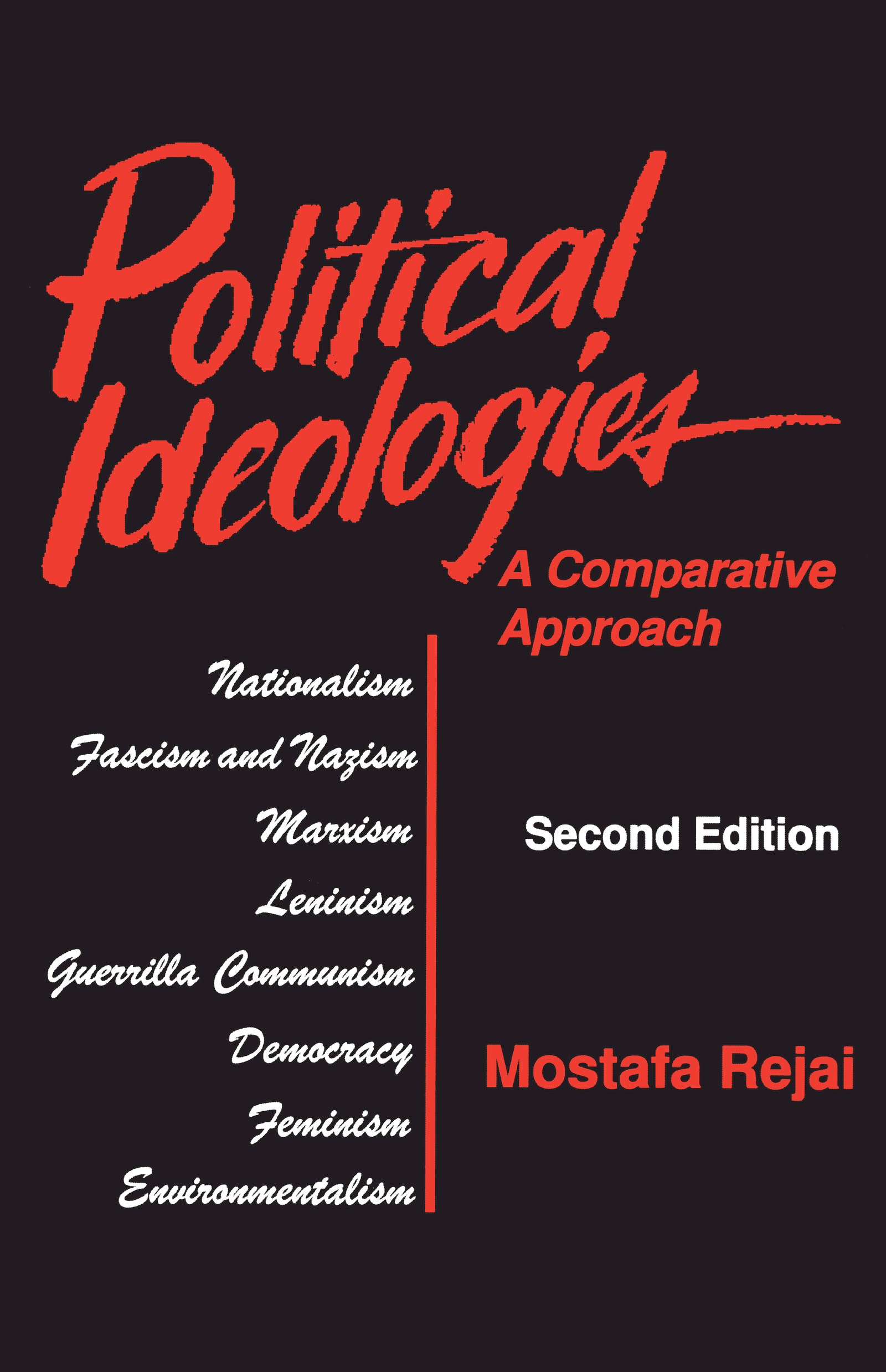
Political Ideologies Designed for classroom use, this book develops a framework for the comparative analysis of political ideologies and examines the most prominent political ideologies of modern time. This revised edition has been enlarged to include feminism and environmentalism. POLITICAL SCIENCE,General
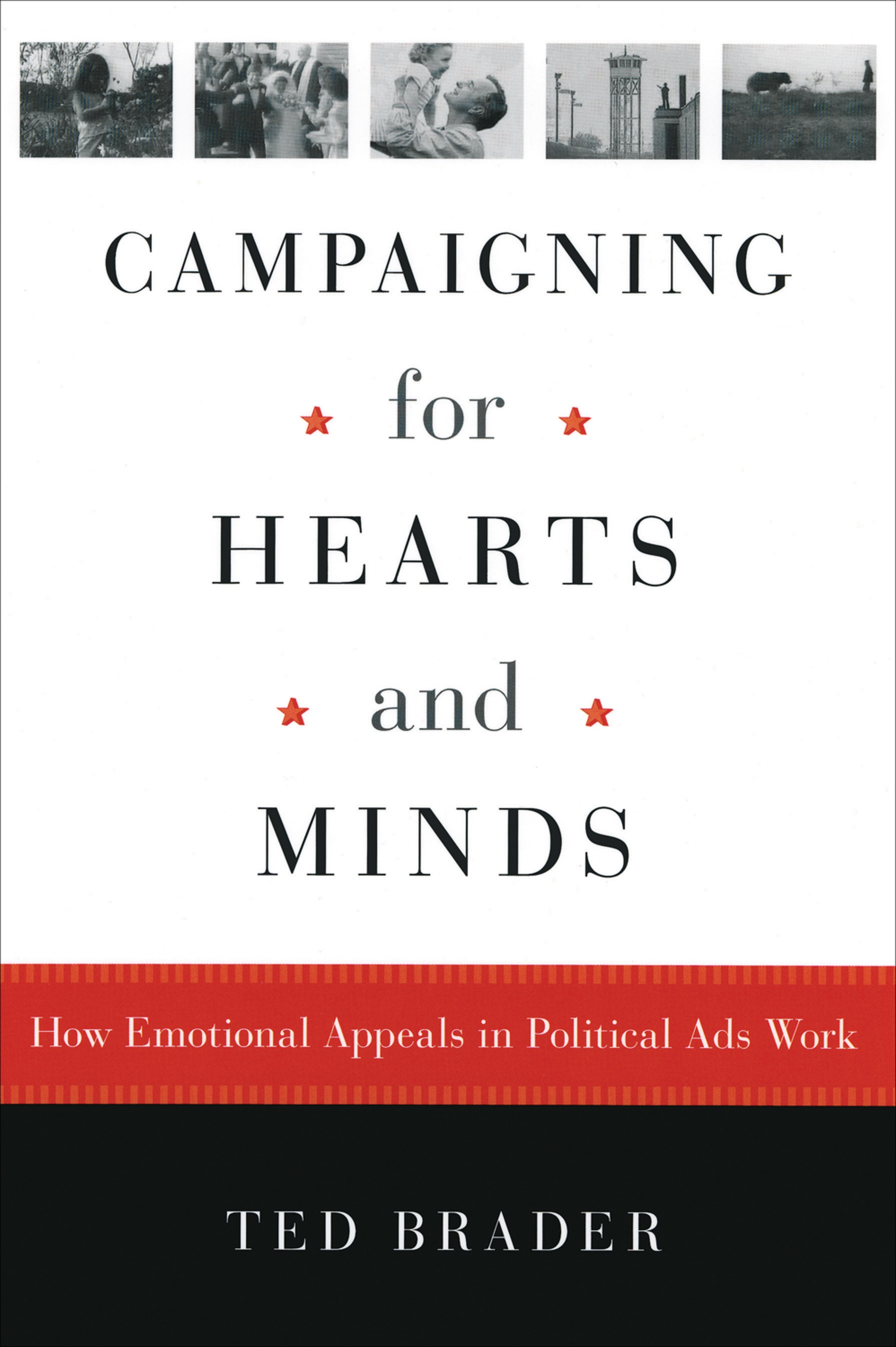
Campaigning for Hearts and Minds It is common knowledge that televised political ads are meant to appeal to voters' emotions, yet little is known about how or if these tactics actually work. Ted Brader's innovative book is the first scientific study to examine the effects that these emotional appeals in political advertising have on voter decision-making. At the heart of this book are ingenious experiments, conducted by Brader during an election, with truly eye-opening results that upset conventional wisdom. They show, for example, that simply changing the music or imagery of ads while retaining the same text provokes completely different responses. He reveals that politically informed citizens are more easily manipulated by emotional appeals than less-involved citizens and that positive "enthusiasm ads" are in fact more polarizing than negative "fear ads." Black-and-white video images are ten times more likely to signal an appeal to fear or anger than one of enthusiasm or pride, and the emotional appeal triumphs over the logical appeal in nearly three-quarters of all political ads. Brader backs up these surprising findings with an unprecedented survey of emotional appeals in contemporary political campaigns. Politicians do set out to campaign for the hearts and minds of voters, and, for better or for worse, it is primarily through hearts that minds are won. Campaigning for Hearts and Minds will be indispensable for anyone wishing to understand how American politics is influenced by advertising today. POLITICAL SCIENCE,General
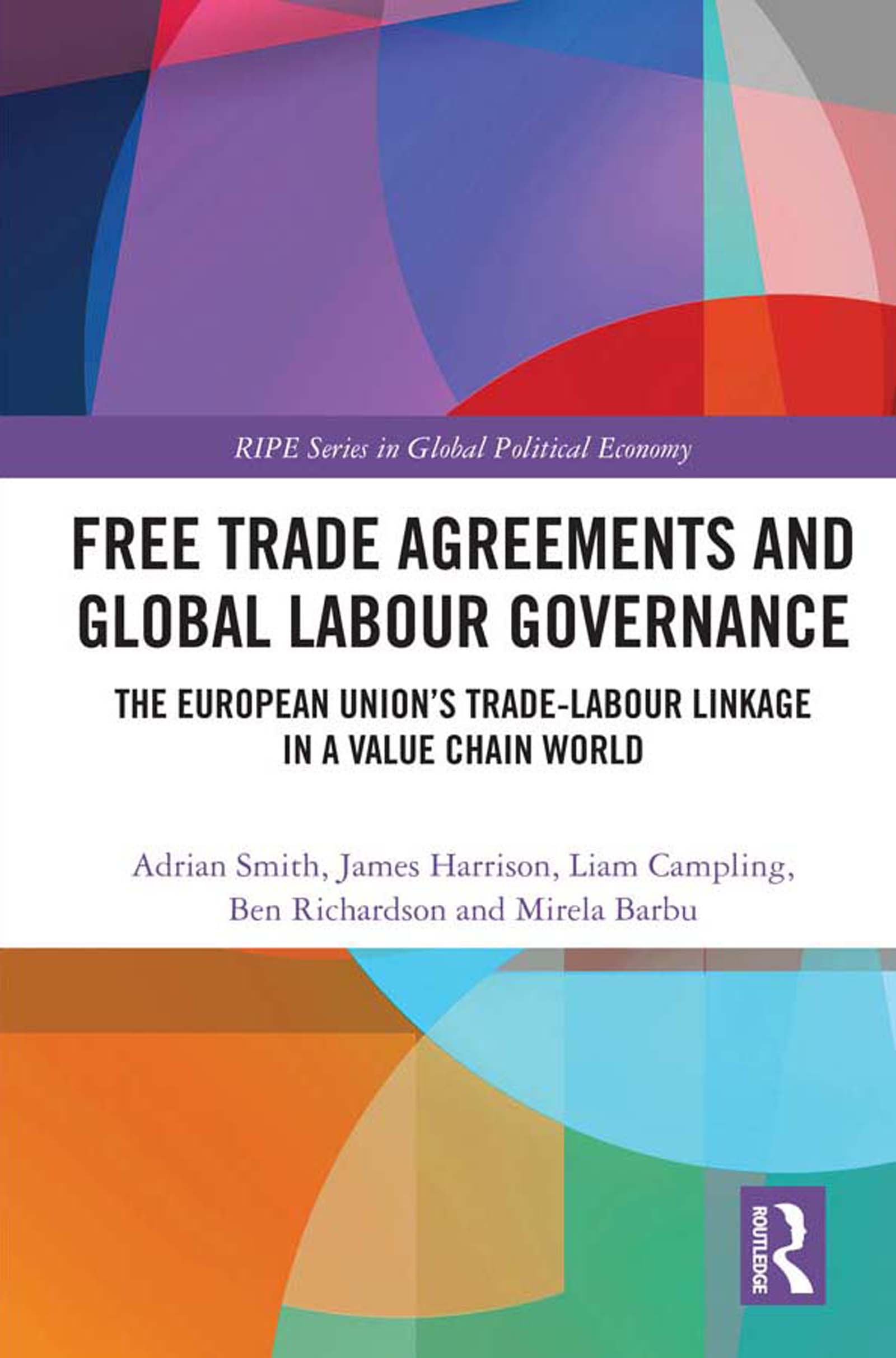
Free Trade Agreements and Global Labour Governance Exploring the contentious relationship between trade and labour, this book looks at the impact of the EU’s ‘new generation’ free trade agreements on workers. Drawing upon extensive original research, including over 200 interviews with key actors across the EU and its trading partners, it considers the effectiveness of the trade-labour linkage in an era of global value chains. The EU believes trade can work for all, claiming that labour provisions in its free trade agreements ensure that economic growth and high labour standards go hand-in-hand. Yet whether these actually make a difference to workers is strongly contested. This book explains why labour provisions have been profoundly limited in the EU’s agreements with the CARIFORUM group, South Korea and Moldova. It also shows how the provisions were mismatched with the most pressing workplace concerns in the key export industries of sugar, automobiles and clothing, and how these concerns were exacerbated by the agreements’ commercial provisions. This pioneering approach to studying the trade-labour linkage provides insights into key debates on the role of civil society in trade governance, the relationship between public and private labour regulation, and the progressive possibilities for trade policy in the twenty-first century. This book will appeal to research scholars, post-graduate students, trade policy practitioners, policy researchers allied to labour movements, and informed activists. POLITICAL SCIENCE,General

Religion and Politics Offering a timely new appraisal of the political and social impact of Islam, Religion and Politics will be welcomed by political scientists and historians alike. In this work, Jan-Erik Lane and Hamadi Redissi employ a Weberian approach, underlining the social consequences of religious beliefs, to account for the political differences between the major civilizations of the world against the background of the rise of modern capitalism in the Occidental sphere. Compared with Weber and his emphasis upon economic modernization, the perspective on religion is broadened to encompass post-modernity; particular attention is paid to human rights and the rule of law. This thought-provoking work raises the question of whether the tenets of Islam might be reconciled with the requirements of post-modernity. POLITICAL SCIENCE,General

Balancing Act Vaughn P. Shannon argues that US foreign policy toward the Arab-Israeli conflict has been determined at three levels of analysis: that of systemic strategic context, that of domestic politics, and that of individual decision-makers. In this book he explores the role of each level of influence, as well as the implications for the posture which the US has chosen. Reflecting changing circumstances, the volume examines the Cold War, the Gulf War and the new 'War on Terror' and how they have each placed differing pressures on US policymakers as they strive to maintain the ultimate strategic goal of preserving regional oil from becoming dominated by hostile forces. It is suitable for courses on American foreign policy, world politics and politics of the Middle East. POLITICAL SCIENCE,General

Australian Security After 9/11 Debates on security became more intense following the unanticipated end of the Cold War conflict and took on added force after the terrorist attacks on the US on September 11, 2001. Generally viewed as a part of the wider 'West' despite its separation by enormous geographical distances from both Europe and the United States, Australia is a regional power in its own right. It has been an active and loyal member of the US-led coalitions of the willing, first in Afghanistan and then in Iraq. The terrorist attacks in Bali one year after the attacks in the United States brought home to Australia the direct nature of the new global terrorist threats to its own security. This volume brings together leading experts on international security and Australia's foreign and security policies in a critical examination of Australia's adaptations to the new security challenges. It is the first in-depth and comprehensive analysis of Australia's defence and security policies as well as the country's role in countering regional and global challenges to international security since the war on terrorism began. POLITICAL SCIENCE,General
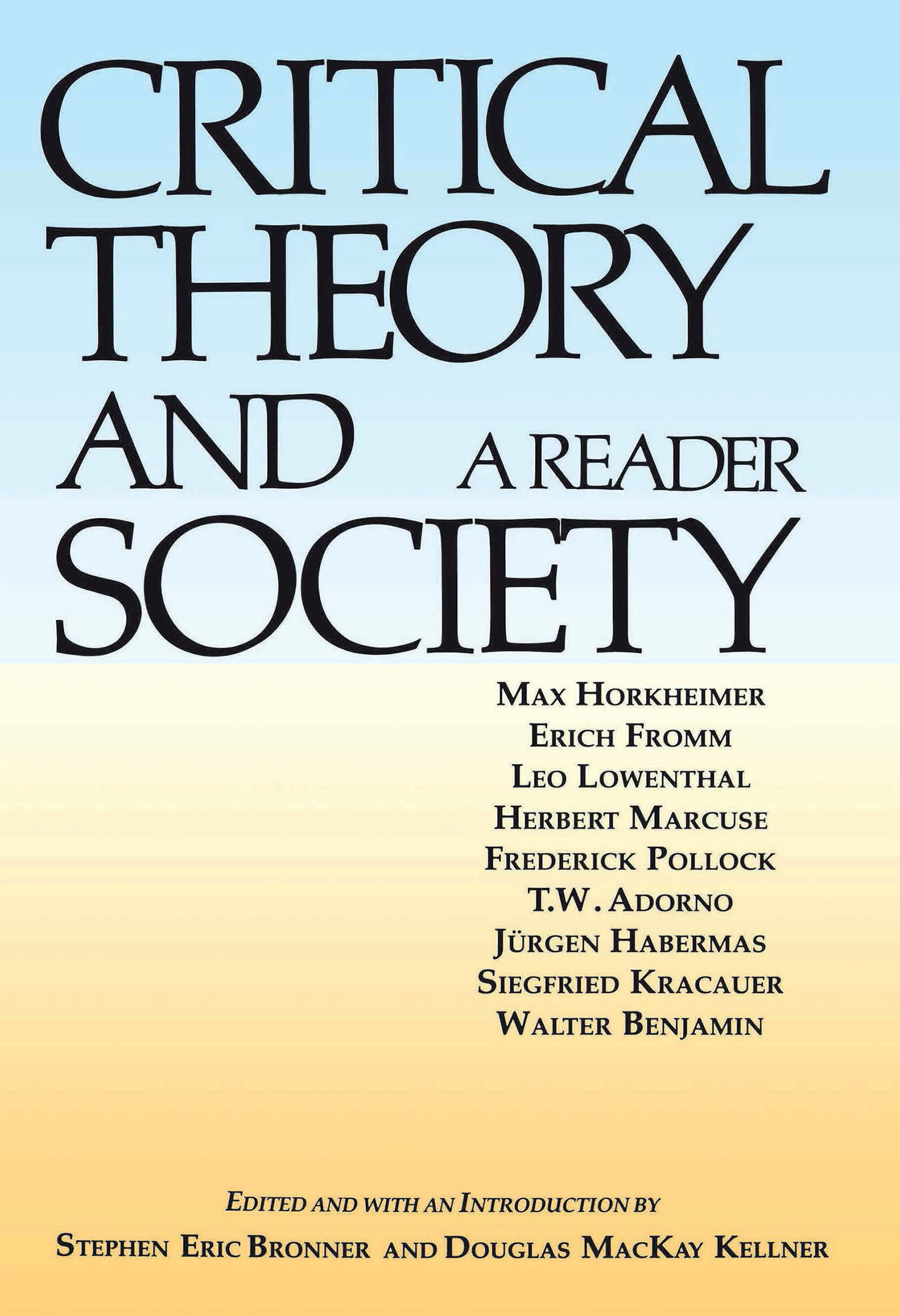
Critical Theory and Society A collection of seminal essays, many appearing in English for the first time, which provides an excellent overview of the critical theory developed by the Frankfurt School. POLITICAL SCIENCE,General
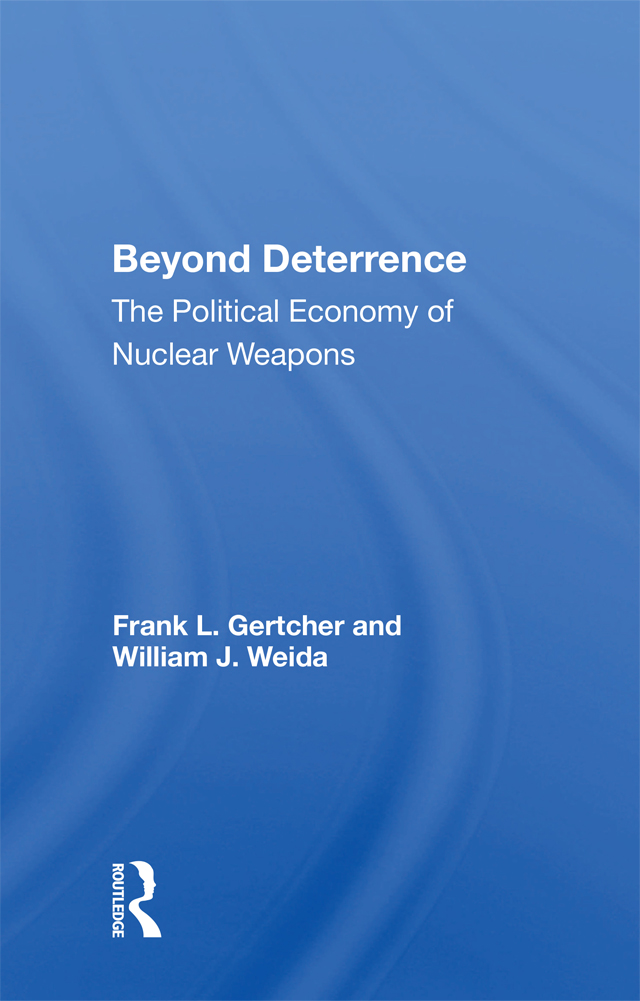
Beyond Deterrence This book is designed for people who wish to increase their understanding of the political economy of nuclear weapon production and proliferation. It explains the role of military, political, and economic incentives in perpetuating the continued growth of worldwide nuclear arsenals. POLITICAL SCIENCE,General
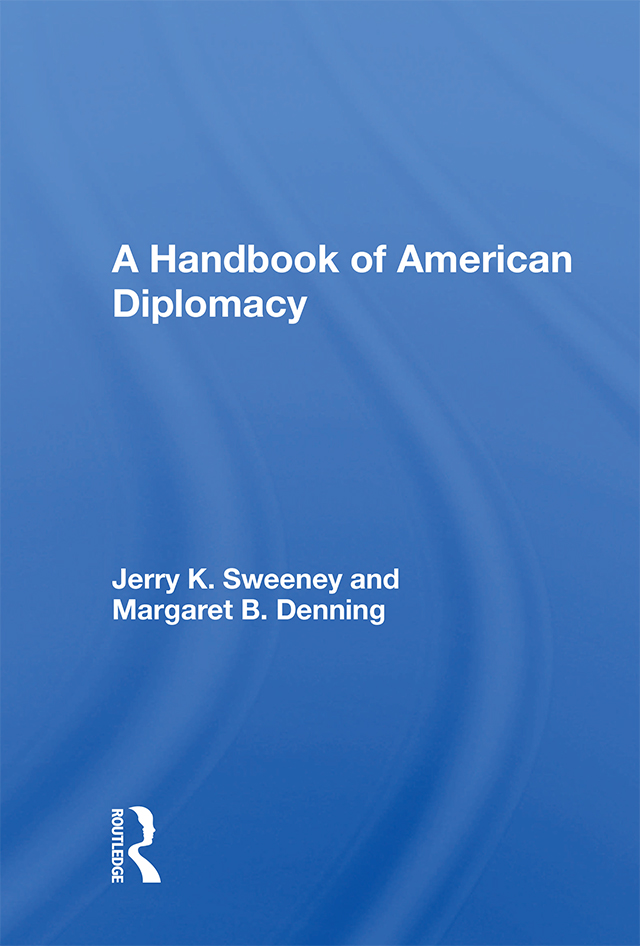
A Handbook Of American Diplomacy This work is concerned with the diplomatic history of the United States since the first settlers set foot on the shores of the continent. It is a handbook to serve a general public interested in American diplomacy as well as students engaged in course work in that area. POLITICAL SCIENCE,General
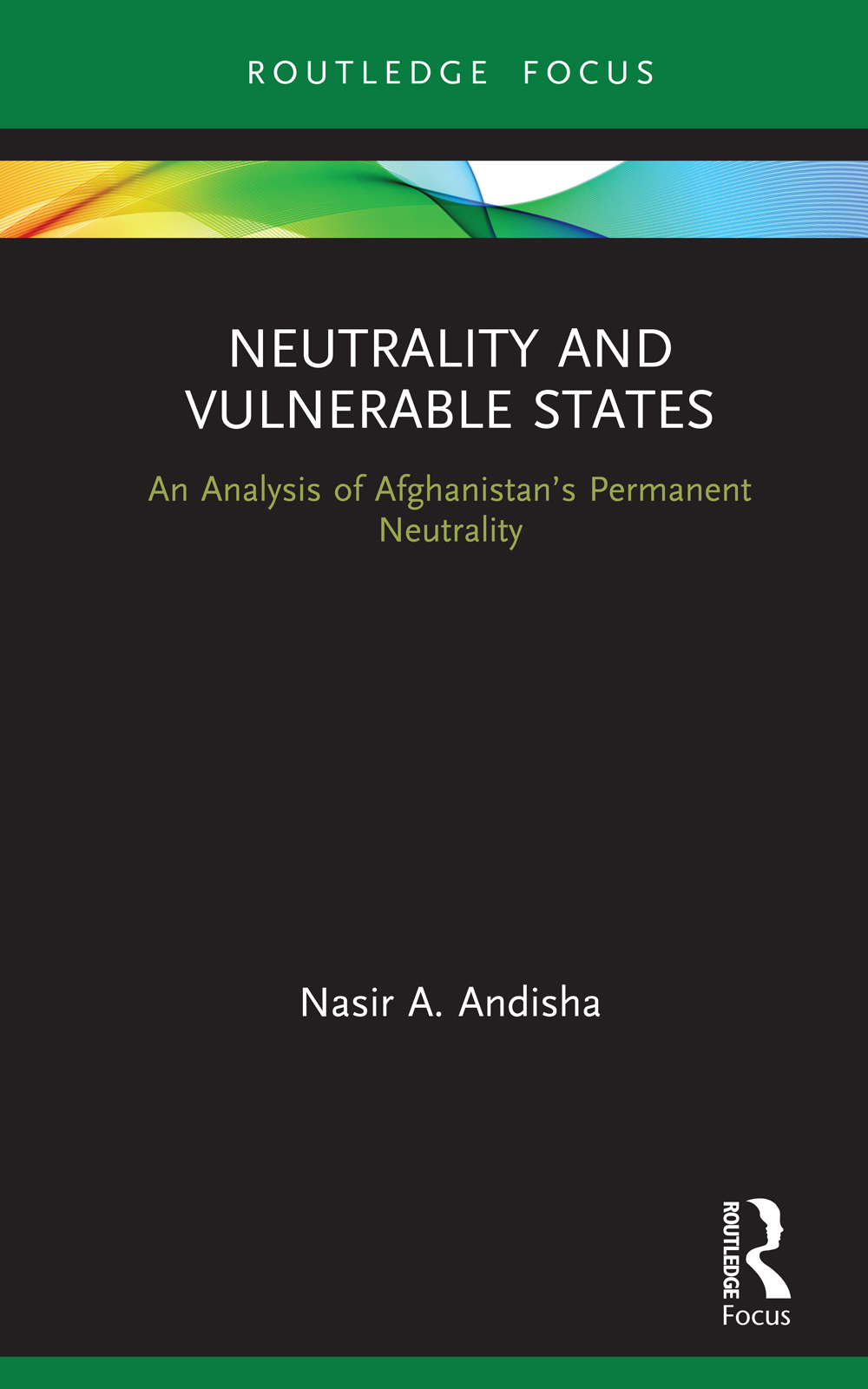
Neutrality and Vulnerable States This book offers a timely and concise academic and historical background to the concept and practice of neutrality, a relatively new phenomenon in foreign and security policy. It approaches two key questions: under what circumstances can permanent neutrality be applied, and what are the main ingredients of success and the causes of failure in applying permanent neutrality? By evaluating, comparing, and contrasting the two successful European case studies of Austria and Switzerland and the two challenging Asian case studies of Afghanistan and Laos, the author creates a new framework of analysis to explore the feasibility of reframing, adopting, and applying a policy of neutrality and jump start debates on the feasibility of the idea of “new neutralityâ€. He opens the debate by asking whether, as neutrality successfully functioned as a conflict resolution tool during the Cold War, a reframed and adopted version of neutrality could also serve the needs of the twenty-first-century world order. This is an insightful book for all scholars, students, and policymakers workingin international relations, security studies, the history of neutrality, and Afghanistan studies. POLITICAL SCIENCE,General

Imagining America at War Ten films released between 9/11 and Gulf War II reflect raging debates about US foreign policy and what it means to be an American. Tracing the portrayal of America in the films Pearl Harbor (World War II); We Were Soldiers and The Quiet American (the Vietnam War); Behind Enemy Lines, Black Hawk Down and Kandahar (episodes of humanitarian intervention); Collateral Damage and In the Bedroom (vengeance in response to loss); Minority Report (futurist pre-emptive justice); and Fahrenheit 9/11 (an explicit critique of Bush’s entire war on terror), Cynthia Weber presents a stimulating new study of how Americans construct their identity and the moral values that inform their foreign policy. This is not just another book about post-9/11 America. It introduces the concept of 'moral grammars of war', and explains how they are articulated: Many Americans asked in the wake of 9/11 – not only 'why do they hate us?' but 'what does it mean to be a moral America(n) and how might such an America(n) act morally in contemporary international politics? This text explores how these questions were answered at the intersections of official US foreign policy and post-9/11 popular films. It also details US foreign policy formation in relation to traditional US narratives about US identity ‘who we think we were/are’, 'who we wish we’d never been', 'who we really are', and 'who we might become' as well as in relation to their foundations in nationalist discourses of gender and sexuality. This book will be of great interest to students of American Studies, US Foreign Policy, Contemporary US History, Cultural Studies, Gender and Sexuality Studies and Film Studies. POLITICAL SCIENCE,General
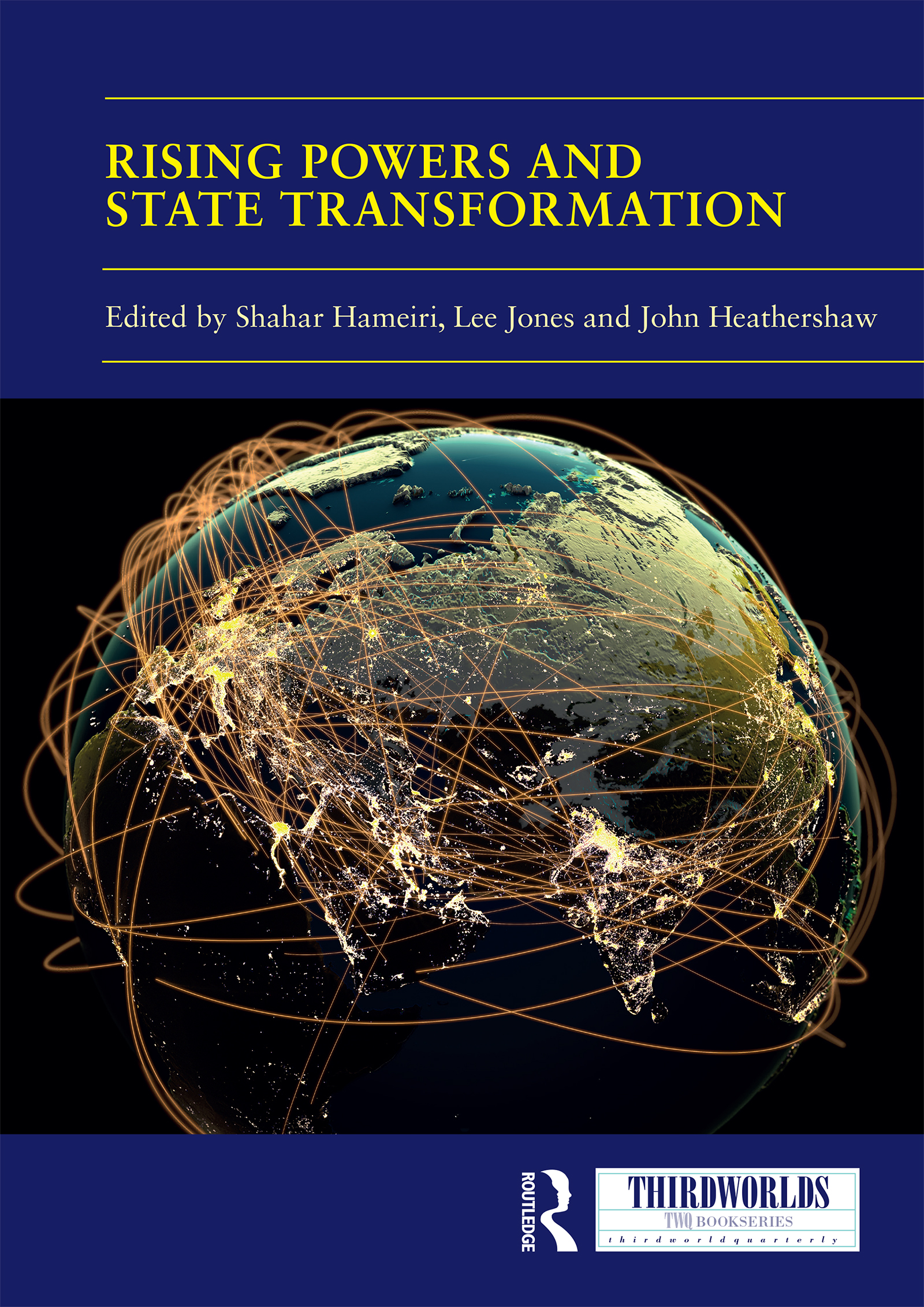
Rising Powers and State Transformation Rising Powers and State Transformation advances the concept of ‘state transformation’ as a useful lens through which to examine rising power states’ foreign policymaking and implementation, with chapters dedicated to China, Russia, India, Brazil, Indonesia and Saudi Arabia. The volume breaks with the prevalent tendency in International Relations (IR) scholarship to treat rising powers as unitary actors in international politics. Although a neat demarcation of the domestic and international domains, on which the notion of unitary agency is premised, has always been a myth, these states’ uneven integration into the global political economy has eroded this perspective’s empirical purchase considerably. Instead, this volume employs the concept of ‘state transformation’ as a lens through which to examine rising power states’ foreign policymaking and implementation. State transformation refers to the pluralisation of cross-border state agency via contested and uneven processes of fragmentation, decentralisation and internationalisation of state apparatuses. The volume demonstrates the significance of state transformation processes for explaining some of these states’ key foreign policy agendas, and outlines the implications for the wider field in IR. With chapters dedicated to all of today’s most important rising power states, Rising Powers and State Transformation will be of great interest to scholars of IR, international politics and foreign policy. The chapters were originally published as a special issue of Third World Quarterly. POLITICAL SCIENCE,General
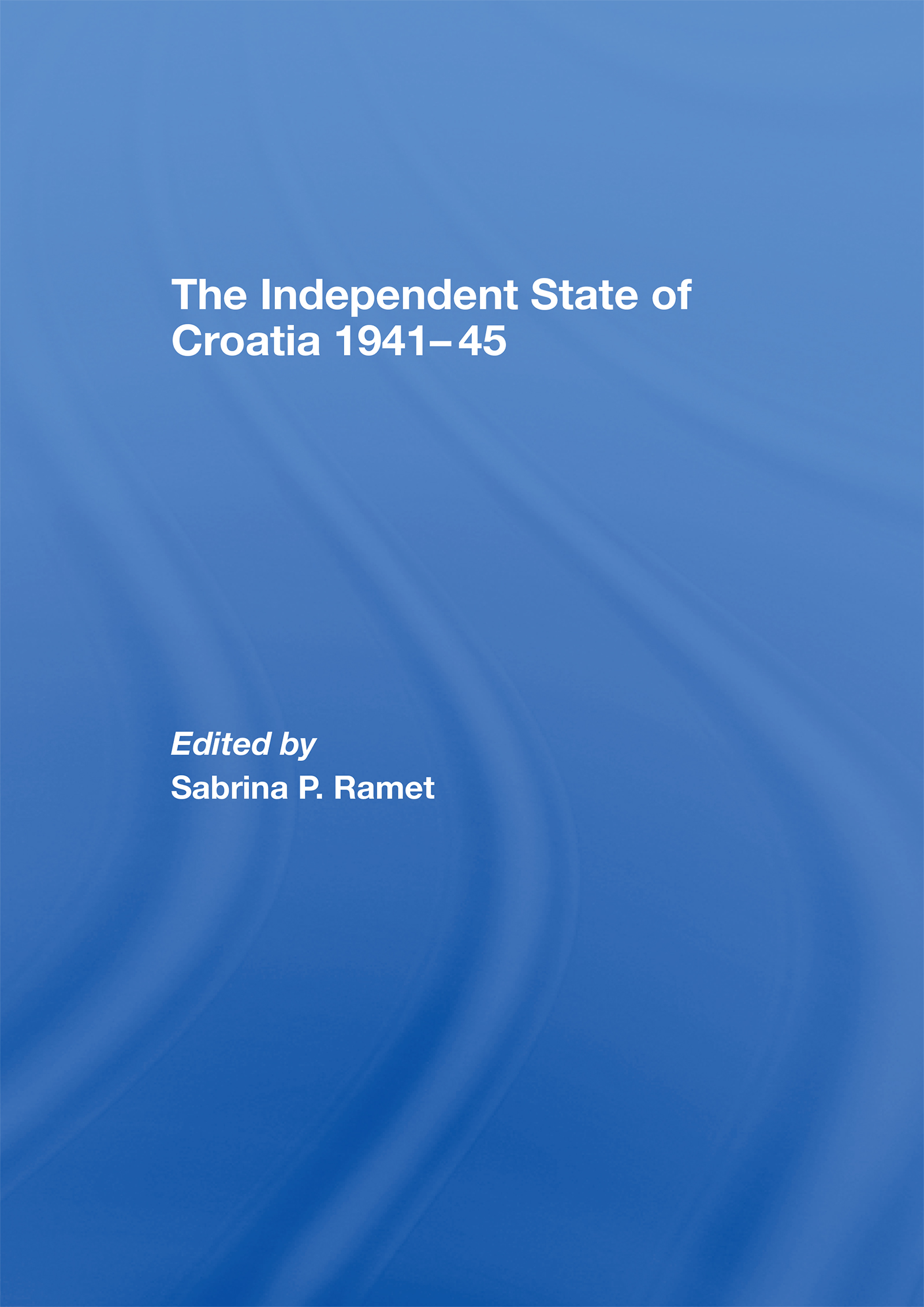
The Independent State of Croatia 1941-45 This special issue provides important new scholarship from a variety of perspectives on the structure, ideology and political history of the central fascist group in interwar and Second World War Yugoslavia, the Croatian Ustasha. It is the first volume in English to closely explore the Ustasha’s Independent State of Croatia between 1941 and 1945, a period when it was an active collaborator with Nazi Germany and Fascist Italy, and largely responsible for Yugoslavia suffering the highest proportion of national casualties in the Second World War. By using the top scholars in the field to explore the nature of the NDH, The Independent State of Croatia 1941-45 contributes to scholarly understandings of Croatian nationalism, Balkan politics, European fascism, and genocide in the Second World War. POLITICAL SCIENCE,General

People's Lawyers Throughout America's history, lawyers with a crusading zeal have, through their moral stance, intellectual integrity, and sheer brilliance, made use of the law to fight social injustice. In short biographical chapters, the authors tell the stories of ten of these lawyers. Some are well known: Thurgood Marshall; William Kunstler; Louis Brandeis; Morris Dees; Clarence Darrow; and Ralph Nader. Others are not so well known, but deserve to be. All are fascinating and influential attorneys, and examination of their lives illuminates key issues in American history. An annotated bibliography; a chronology of the person's life and work; and a helpful table detailing their most prominent cases accompany each chapter. POLITICAL SCIENCE,General
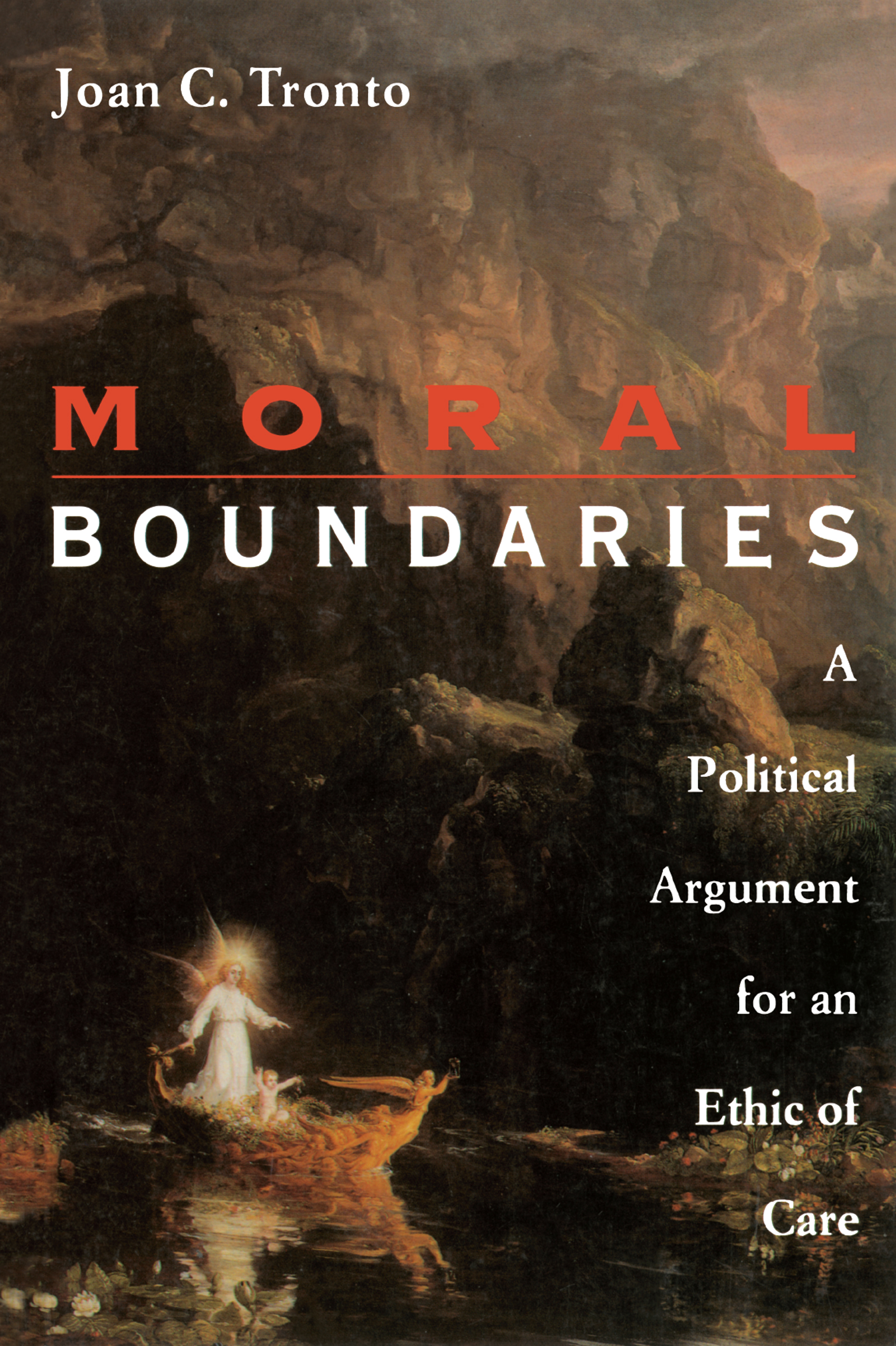
Moral Boundaries In Moral Boundaries Joan C. Tronto provides one of the most original responses to the controversial questions surrounding women and caring. Tronto demonstrates that feminist thinkers have failed to realise the political context which has shaped their debates about care. It is her belief that care cannot be a useful moral and political concept until its traditional and ideological associations as a "women's morality" are challenged. Moral Boundaries contests the association of care with women as empirically and historically inaccurate, as well as politically unwise. In our society, members of unprivileged groups such as the working classes and people of color also do disproportionate amounts of caring. Tronto presents care as one of the central activites of human life and illustrates the ways in which society degrades the importance of caring in order to maintain the power of those who are privileged. POLITICAL SCIENCE,General
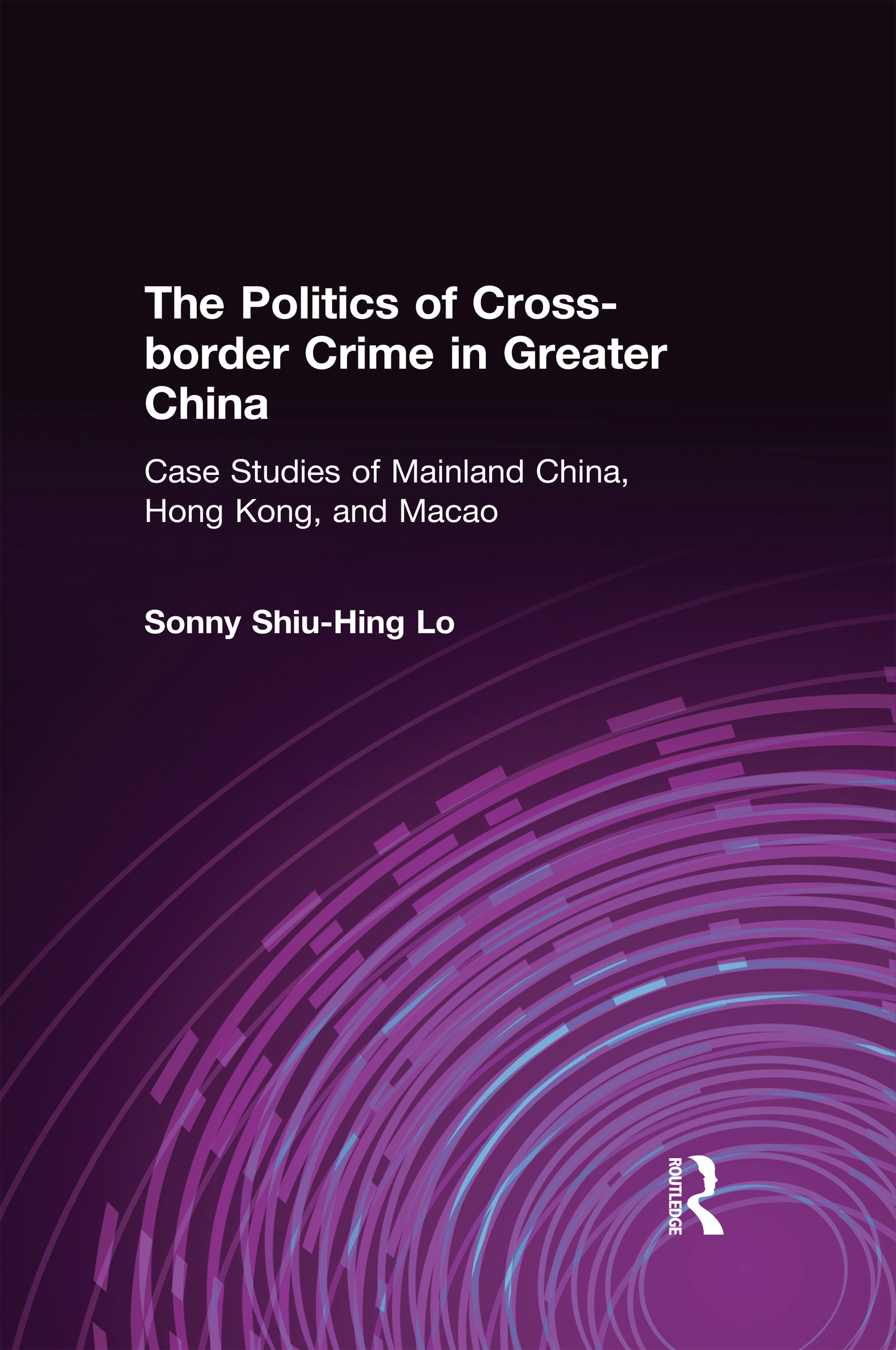
The Politics of Cross-border Crime in Greater China Organized crime has been on the rise in the Greater China region since the People's Republic opened up its economy and society in the mid-1980s. Today, triads from Hong Kong, Macao, and even Taiwan are involved in businesses in Guangdong Province, and often recruit local Chinese for illegal activities such as extortion, kidnapping, assassinations, and smuggling of illegal aliens.This book provides a detailed and comprehensive study of how the state at the central and local levels has responded to the changing patterns and activities of cross-border crime in Greater China. It discusses the theoretical concept of organized crime; the transnational nature of organized crime in recent years; the significance of studying organized crime in Greater China; and the implications for the national security of other countries such as the United States, Canada, and Australia.The author reviews the history of organized crime and secret societies, and addresses the legal complexities of dealing with criminal groups in the region. He covers such topics as money laundering, the financing of terrorist activities, and regional efforts in fighting terrorism. POLITICAL SCIENCE,General
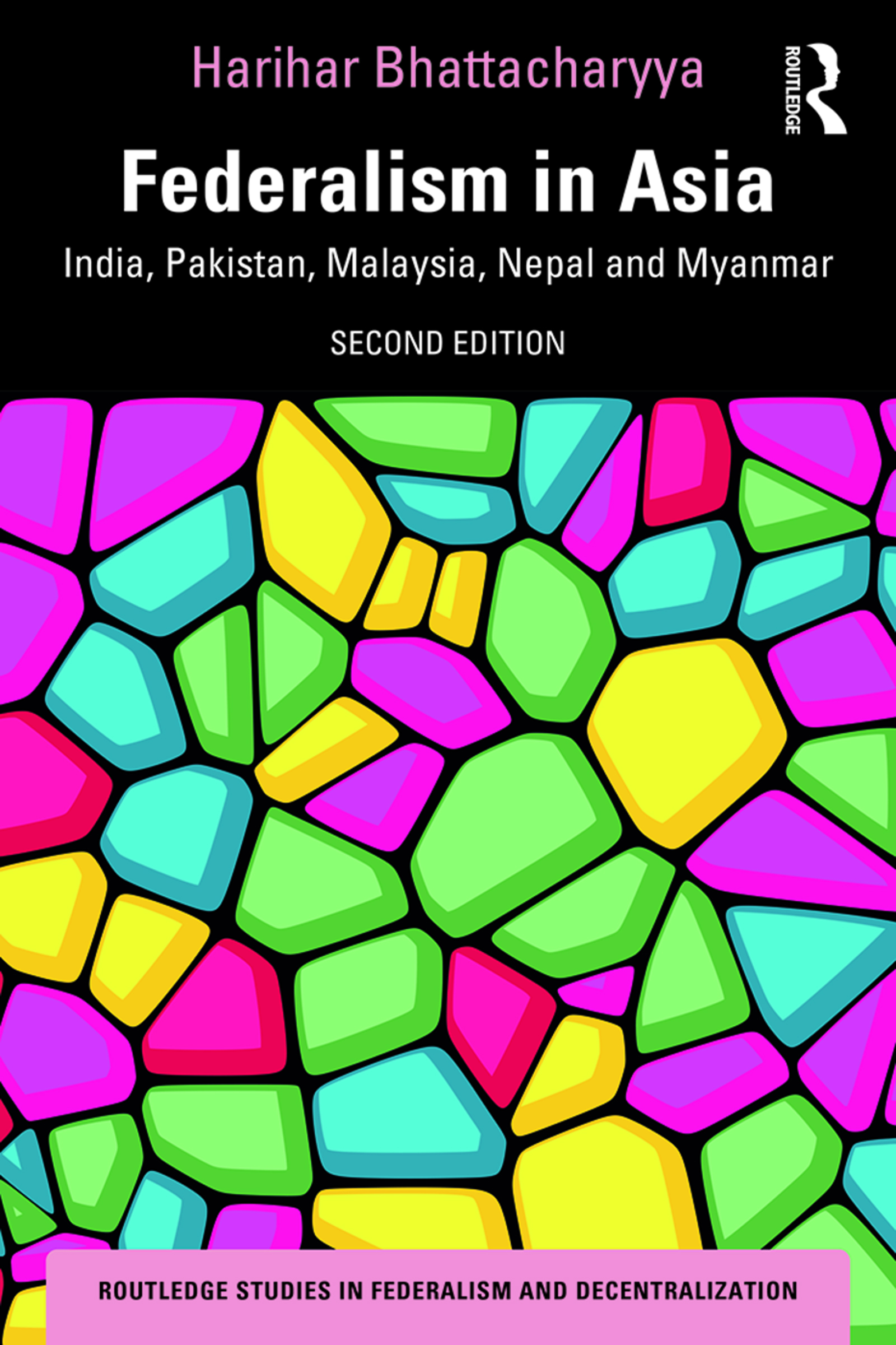
Federalism in Asia This comprehensive book critically analyzes the successes and failures of federalism in India, Pakistan, Malaysia, Nepal and Myanmar for the political accommodation of ethno-regional diversity and assesses their comparative democratic significance for other countries in Asia. This revised new edition incorporates updated demographic, religious and linguistic data for the case study countries and examines some of the major changes that have taken place in formally federal states since 2010, including the 18th Amendment of the Constitution in Pakistan in 2010, which gave a major turn to decentralization by empowering the provinces; the new federal democratic Constitution that was introduced in Nepal in 2015; and the abolition of the Planning Commission and the National Development Council in India. The author thematically examines the growing tensions between nation and state-building in ethnically plural societies; modes of federation-building in Asia; persistent ethnic tensions in federations and the relationship between federalism and democracy; and federalism and decentralization. The book will be of use to advanced undergraduate and postgraduate students of Asian politics, comparative federalism and modern Asian political history and institutions, as well as policy makers on ethnic conflict regulation and peace studies and stakeholders in ethnic power-sharing and political order. POLITICAL SCIENCE,General

The European Union Thoroughly revised, the seventh edition of this accessible and highly respected text provides a rigorous yet digestible introduction to the European Union. Additionally, it authoritatively explains developments that continue to bring challenges to this powerful institution in times of great political change. Key features: Clearly covers the history, governing institutions, and policies of the EU; Fully updated with new tables, figures, and photographs; In-text features such as Chapter Overviews, Questions to Consider, and Further Reading encourage deeper research and debate; Sustained discussion of transformative and historical change in the upheaval of Brexit and its ramifications, and the future relationship of the UK with the EU; Through reflection on destabilizing issues such as immigration and the years of refugee crisis in Europe, the continued crisis in the eurozone, tensions with Poland and Hungary, Euroskepticism, Russia, and the rise of populism; Increased coverage throughout of women or minorities within the EU. Jonathan Olsen presents the EU as one of the world's economic and political superpowers, which has brought far-reaching changes to the lives of Europeans and has helped its member states to take a newly assertive role on the global stage. Essential reading for students of European and EU politics, this book offers an up-to-the-minute look at both the opportunities and existential threats facing the EU. POLITICAL SCIENCE,General
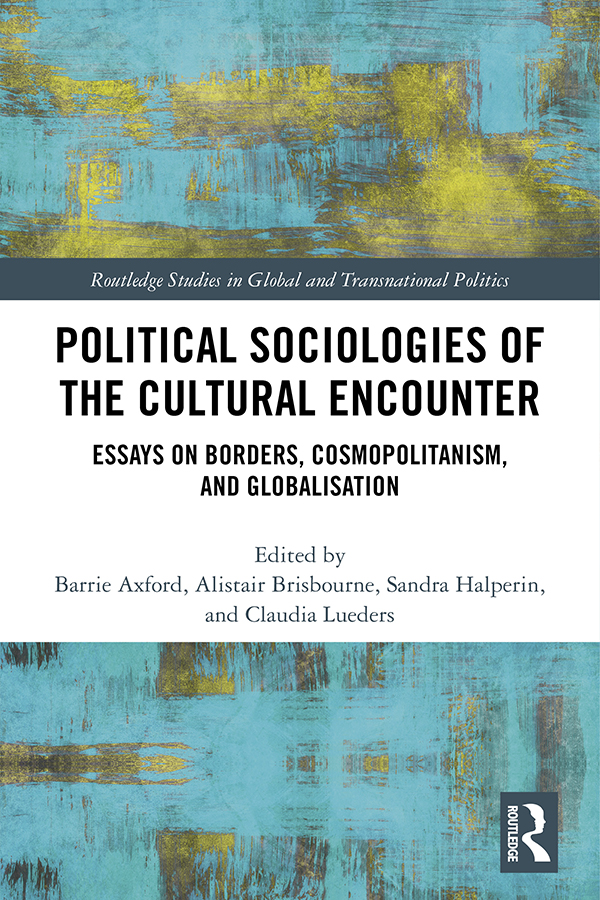
Political Sociologies of the Cultural Encounter This book offers transdisciplinary scholarship which challenges the agendas of and markers around traditional social scientific fields. It builds on the belief that the study of major issues in the global cultural and political economies benefit from a perspective that rejects the limitations imposed by established boundaries, whether disciplinary, conceptual, symbolic or material. Established and early career academics explore and embrace contemporary political sociology following the ‘global’ and ‘cultural’ turns of recent decades. Categories such as state, civil society, family, migration, citizenship and identity are interrogated and sometimes found to be ill-suited to the task of analyzing global complexities. The limits of global theory, the challenges of global citizenship, and the relationship between globalisation and situated and mobile subjects and objects are all referenced in this book. The book will be of interest to scholars of International Relations, Political Science, Sociology, Political Sociology, Social Theory, Geography, Area studies and European studies. POLITICAL SCIENCE,General
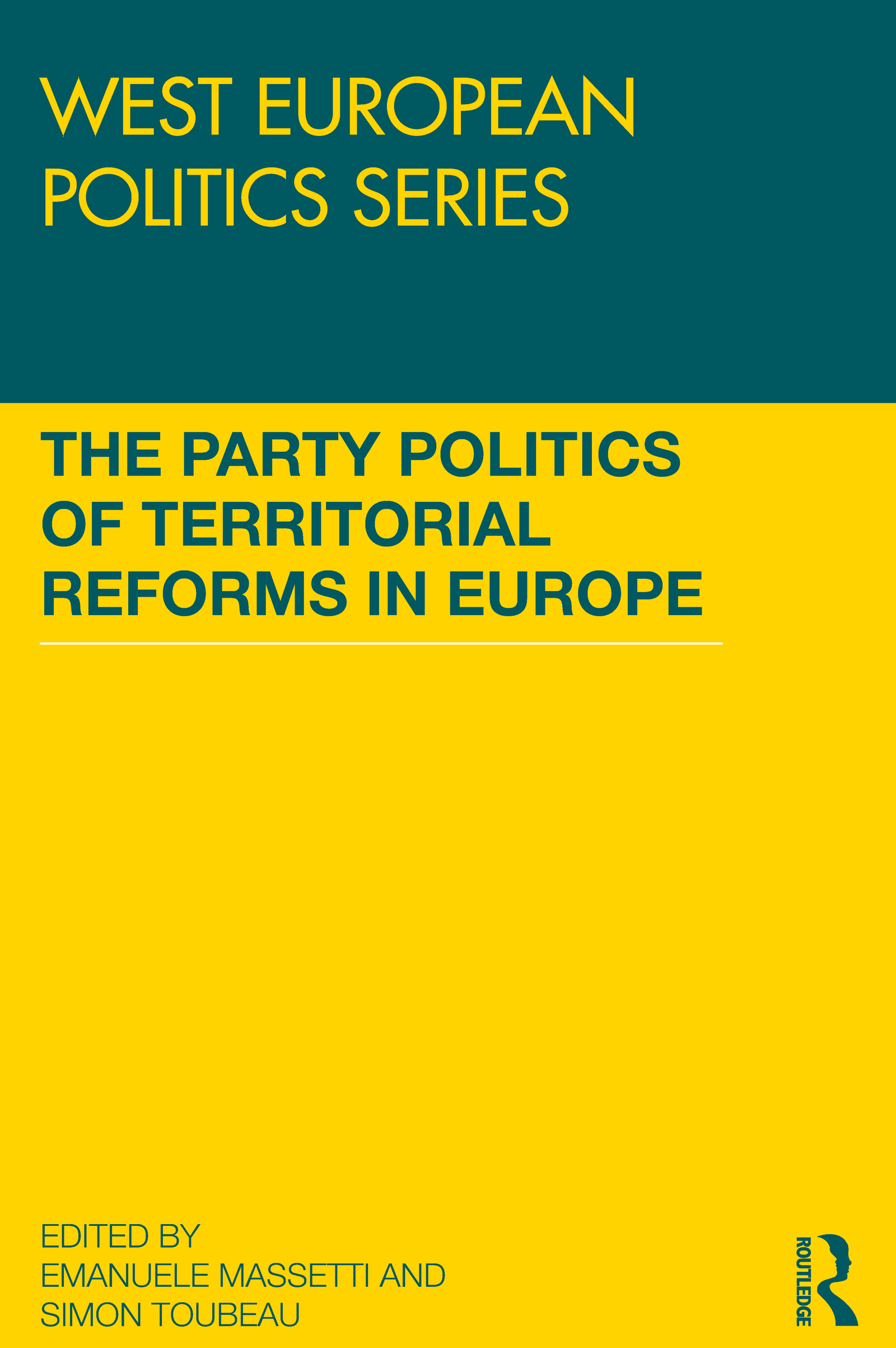
The Party Politics of Territorial Reforms in Europe The book analyses how political parties compete and strategise on the issue of territorial reform using case-studies that include countries from both Western (Belgium, Germany, Italy and Spain) and Central-Eastern Europe (Poland, Slovakia and Romania). Each case-study considers different drivers of decentralization, such as territorial identities and the demands of regionalist parties for territorial autonomy or independence, efficiency concerns related to issues of uneven economic development and economic competitiveness, the pressure from supra-national organizations (especially the EU), as well as different combinations of these drivers. They also consider how the ideology and organisation of state-wide parties and the institutional context in which they compete shape their responses to these drivers and their strategy towards the question of territorial reform. This collection investigates the logic of the actions that guide political parties’ strategy to highlight trends that are apparent across the case-studies. This book was originally published as a special issue of West European Politics. POLITICAL SCIENCE,General
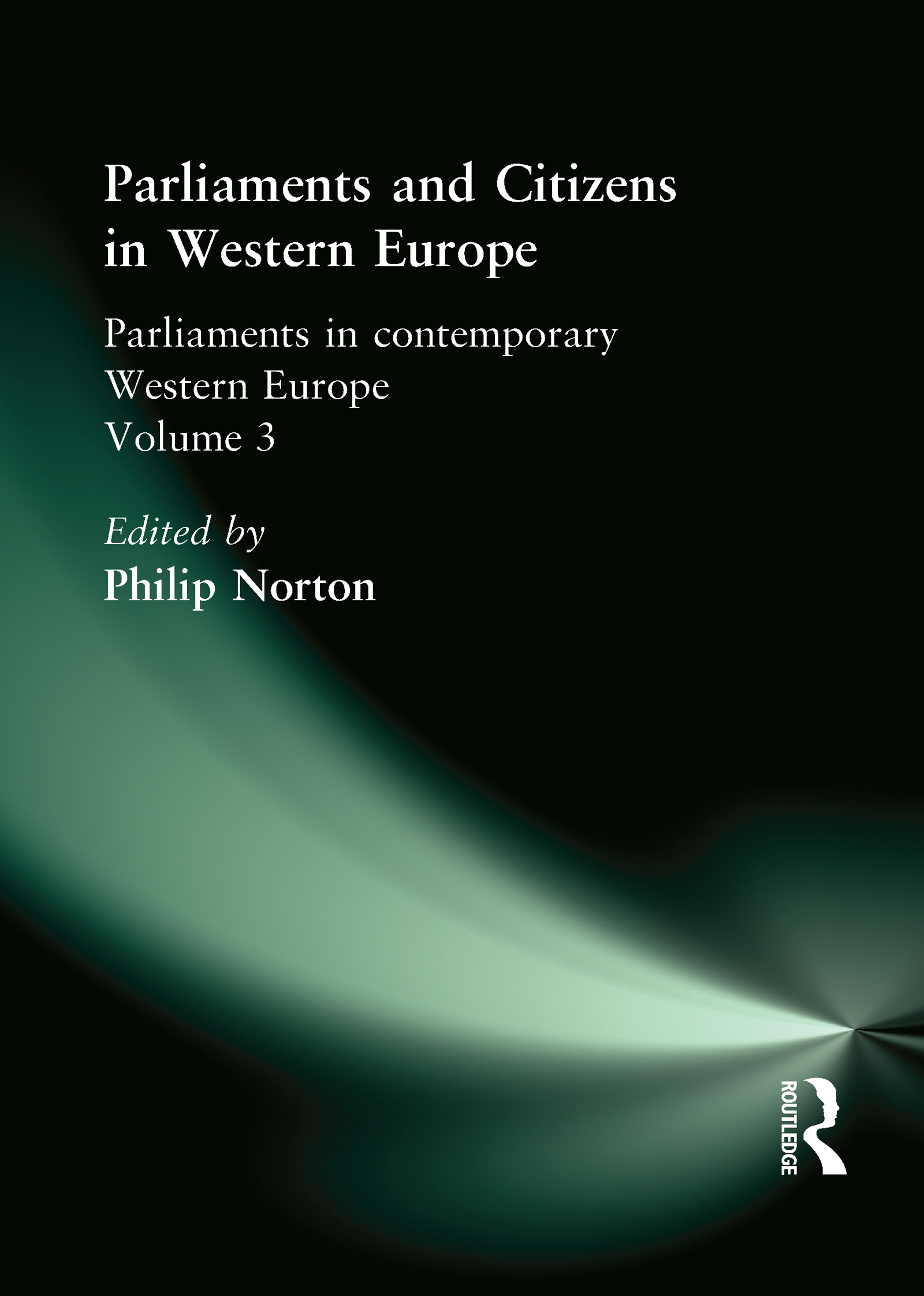
Parliaments and Citizens in Western Europe Citizens elect the parliament, but what contract takes place between citizen and parliament in between elections? The authors assess the extent and nature of that contact. To what extent are members of parliament accessible to the ordinary citizen? And what are the implications for the legislature? Can there be too much, or too little, contact? POLITICAL SCIENCE,General
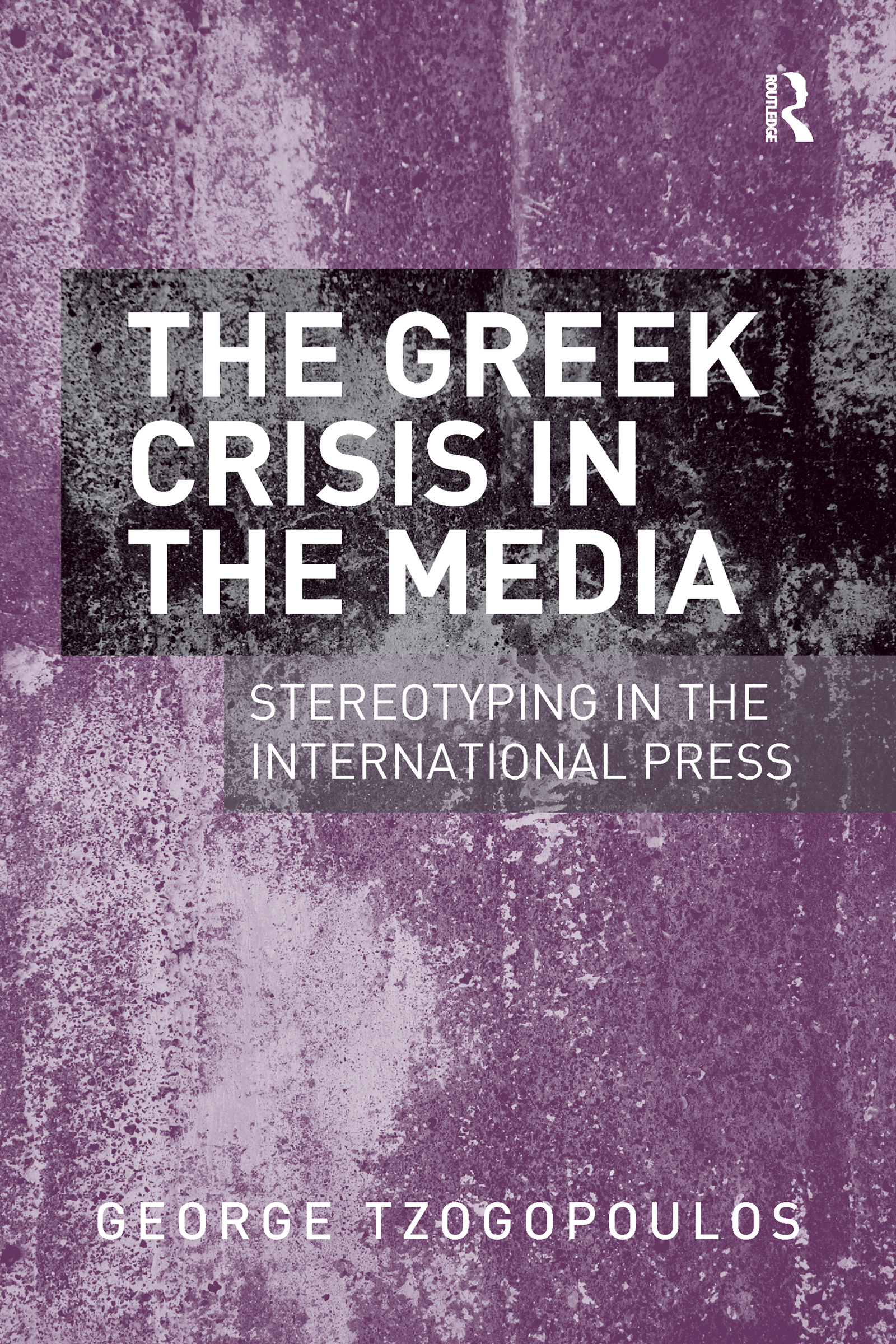
The Greek Crisis in the Media The portrayal of Greece by the international press during the financial crisis has been seen by many independent observers as very harsh. The Greeks have often been blamed for a myriad of international political problems and external economic factors beyond their control. In this original and insightful work George Tzogopoulos examines international newspaper coverage of the unfolding economic crisis in Greece. American, British, French, German and Italian broadsheet and tabloid coverage is carefully analysed. The Greek Crisis in the Media debates and dissects the extent to which the Greek response to the financial crisis has been given fair and balanced coverage by the press and questions how far politics and national stereotypes have played their part in the reporting of events. By placing the Greek experiences and treatment alongside those of other EU members such as Portugal, Ireland, Italy and Spain, Tzogopoulos examines and highlights similarities and differences in the ways in which different countries tackled the challenges they faced during this crucial period and explores how and why the world's media reported these events. POLITICAL SCIENCE,General

Third World Atlas This book focuses on some of the Third World's common experiences, such as its historical linkages with the West, the challenge to provide basic needs, and the effects of competition in the global economy. It will be useful in bringing a spatial and statistical dimension to the study of development. POLITICAL SCIENCE,General

Church-state Relations Encounters between agents of the state and religious organizations have been increasing throughout the world, thus the need to understand the relationships between religion and other major domains of life is increasingly important. In this comprehensive reader on church-state relations, scholars examine the connections between religion and political life from a comparative perspective. POLITICAL SCIENCE,General
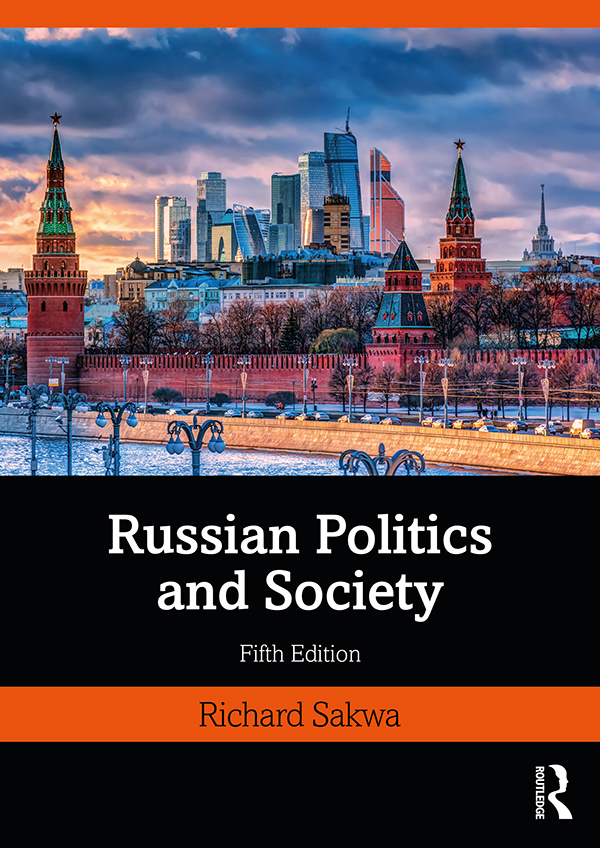
Russian Politics and Society Fully revised and updated to reflect the considerable changes in Russia over the last decade, the fifth edition of this classic text builds on the strengths of previous editions to provide a comprehensive and sophisticated analysis of Russian politics and society. The new edition incorporates the latest debates about Russian politics, analysing recent institutional and political developments, and examines the electoral cycle and prospects of the president elected at the end of the process. New to this edition: an evaluation of Putin’s leadership and the country's political performance under him; updated election results and demographic, social, ethnic/national statistics to include results of the 2010 census; changes in the party system, to electoral legislation and to the composition of parliament as well as the relationship between the executive and legislature; coverage of the constitutional changes and governmental appointments under the various prime ministers; more analysis of economic performance including discussion of the energy sector and pipeline politics; changes in Russian foreign policy since EU enlargement, its relationship with NATO since the ‘reset’, as well as its relations with post-Soviet states; assessment of the military reforms and security and defence policy; debates over the question of democracy in Russia today, the nature of the system, and its future prospects. Written in an accessible and lively style, this book is packed with detailed information on the central debates and issues in Russia’s difficult transformation. An unrivalled textbook on the subject it is essential reading for all those concerned with the fate of Russia, and with the future of international society. POLITICAL SCIENCE,General

Jameson, Althusser, Marx (RLE Marxism) Frederic Jameson is widely regarded as one of the most original and influential Marxist critics of the last decades. His most controversial work, The Political Unconscious, had an enormous impact on literary criticism and cultural studies. In Jameson, Althusser, Marx, first published in 1984, Professor Dowling sets out to provide the intellectual background needed for an understanding of Jameson’s argument and its broader implications. He elucidates the unspoken assumptions that are the foundation of Jameson’s thought – assumptions about how the nature of language, of interpretation and of culture – and shows how Jameson attempts to subsume in an expanded Marxism the critical theories of Derrida, Foucault, Deleuze, Lacan and of structuralism and poststructuralism in general. This lively, concise book will be welcomed by anyone interested in current theoretical debates, in Marxist criticism, and in the wide-ranging implications of Marxist cultural theory for the social sciences, the arts and the study of history. POLITICAL SCIENCE,General
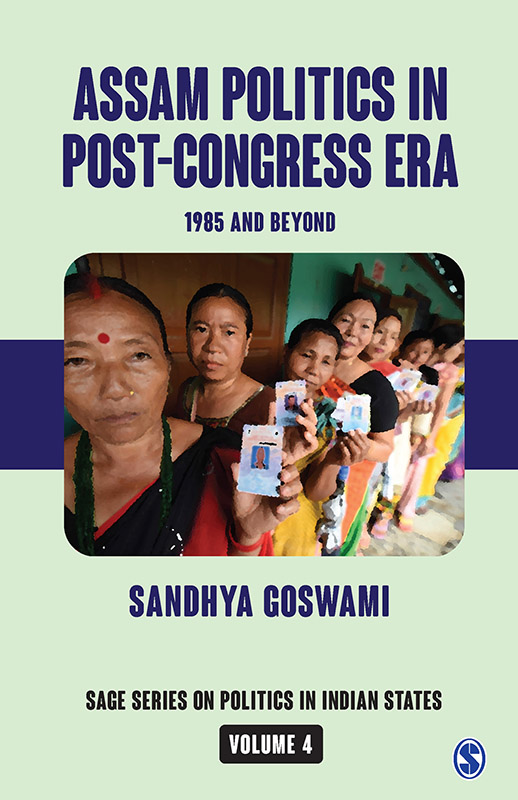
Assam Politics in Post-Congress Era This book focuses on the how the uniqueness of Assam, in terms of its location, geography, social plurality and economy, as well as its history, have shaped the contours of its politics. POLITICAL SCIENCE,General
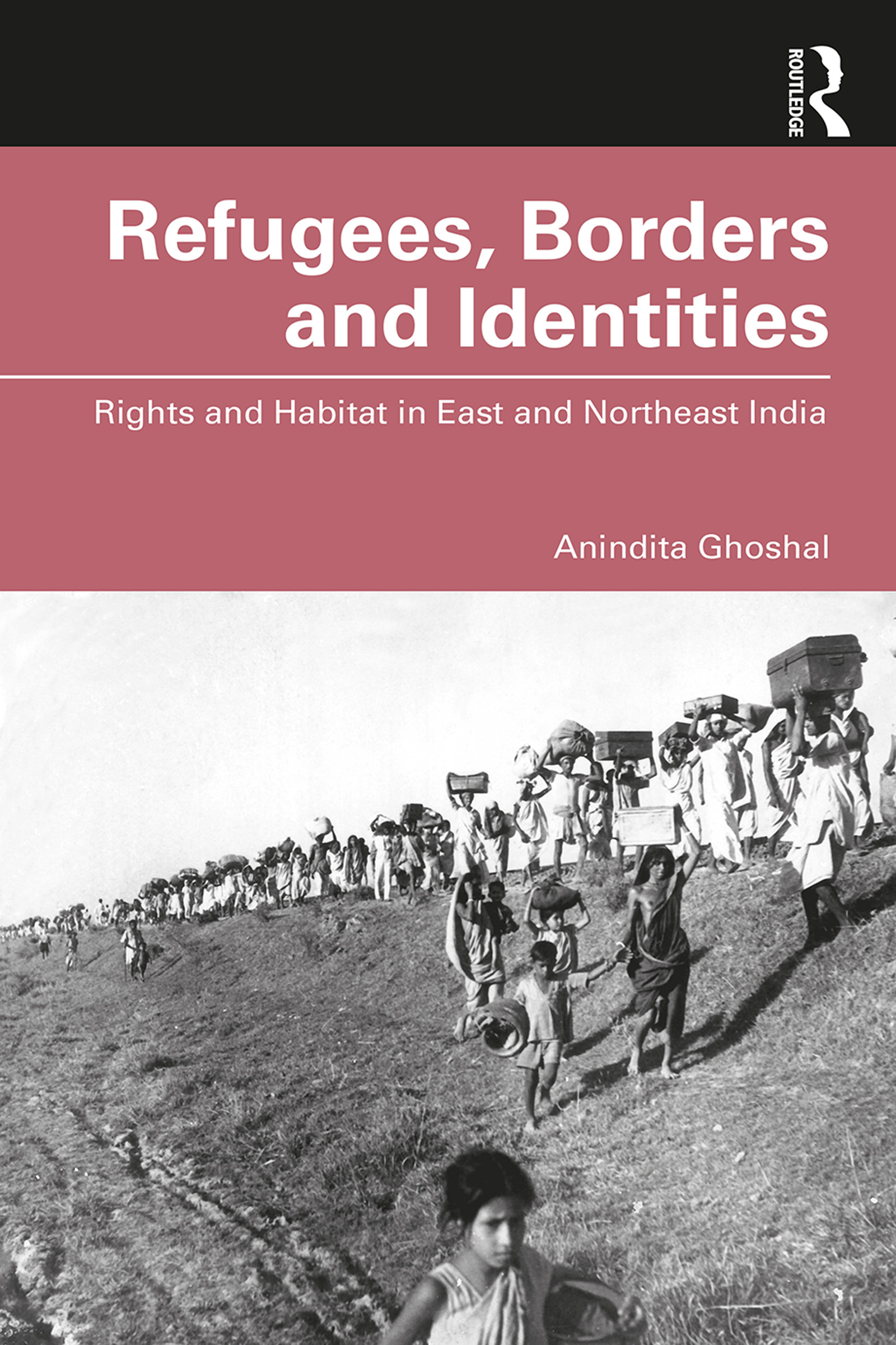
Refugees, Borders and Identities This book examines the impact of Partition on refugees in East and Northeast India and their struggle for identity, space and political rights. In the wake of the legalisation of the Citizenship Amendment Act in 2019, this region remains a hotbed of identity and refugee politics. Drawing on extensive research and in-depth fieldwork, this book discusses themes of displacement, rehabilitation, discrimination and politicisation of refugees that preceded and followed the Partition of India in 1947. It portrays the crises experienced by refugees in recreating the socio-cultural milieu of the lost motherland and the consequent loss of their linguistic, cultural, economic and ethnic identities. The author also studies how the presence of the refugees shaped the conduct of politics in West Bengal, Assam and Tripura in the decades following Partition. Refugees, Borders and Identities will be indispensable for scholars and researchers of refugee studies, border studies, South Asian history, migration studies, Partition studies, sociology, anthropology, political studies, international relations and refugee studies, and for general readers of modern Indian history. POLITICAL SCIENCE,General

Recall! In politics, as in so many other areas, California is unique. The state's economy - the largest in the nation, and sixth largest in the world - is given to dramatic swings. Its legislative system is often defined by gridlock on matters large and small. The use of the initiative, one of the tools of "direct democracy", has become commonplace. Over the years, California has had more than its share of political turmoil. But for pure melodrama, nothing matches the 2003 campaign to recall the state's sitting governor, Gray Davis. Recall! relates the latest and most dramatic chapter in the political history of the Golden State. The authors are recognized experts on California politics and regular local television political analysts. They provide fascinating coverage of the events leading up to Davis's replacement by bodybuilder-turned actor-turned politician Arnold Schwarzenegger; describe the large and colorful cast of characters involved in the special election; and demonstrate how California's one-of-a-kind mix of political, economic, and social circumstances made it all possible. POLITICAL SCIENCE,General
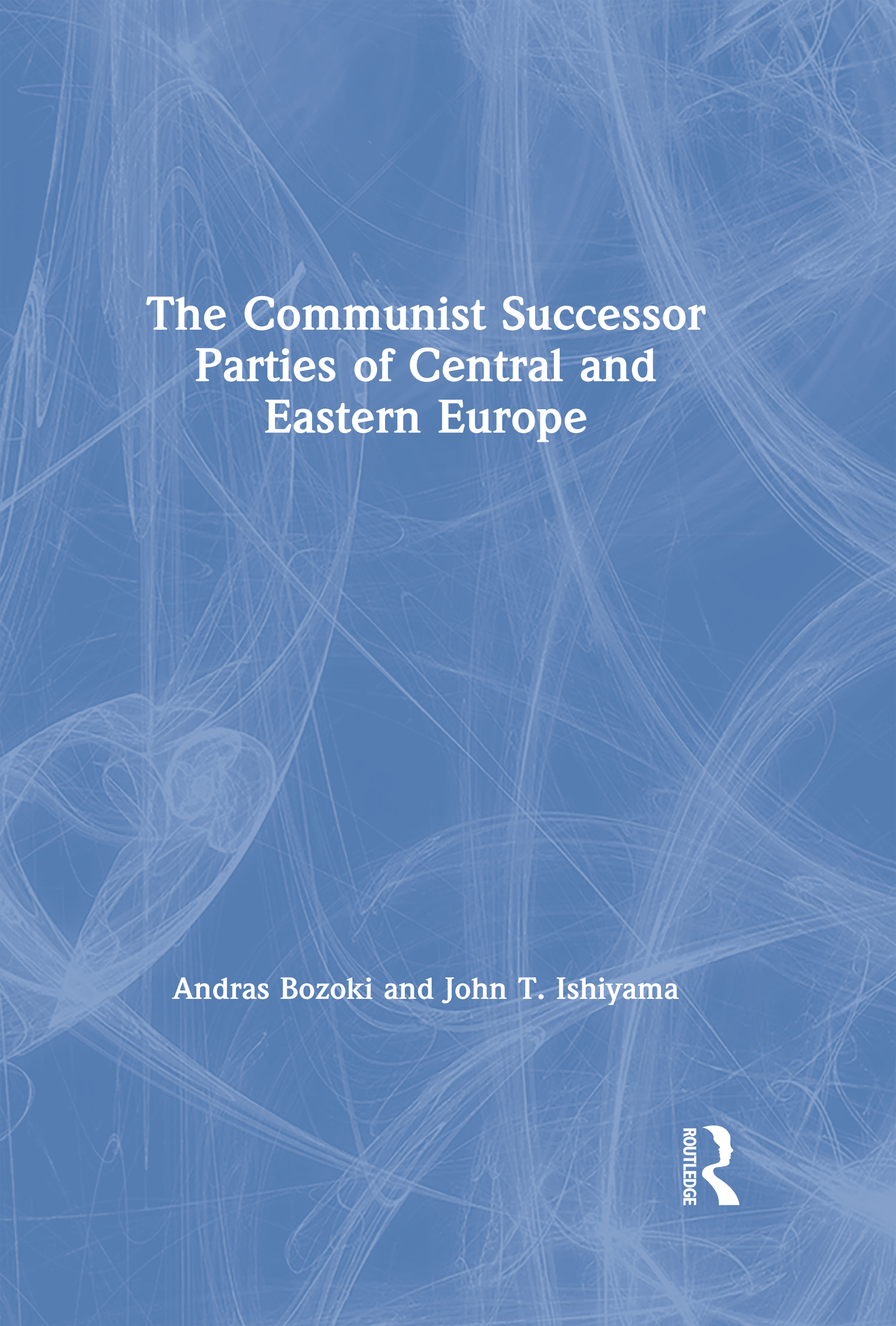
The Communist Successor Parties of Central and Eastern Europe What has become of the Communist parties that once held monopoly power in the east bloc? A decade ago, it was assumed that they would dissolve, but many of them have enjoyed electoral success. This book systematically examines how they have evolved. In the opening section, Herbert Kitschet and Ivan Szelenyi respectively consider post-communist party strategies and social democratic prospects in the transitional societies. Part II presents nine case studies of the major communist and communist successor parties of the region, and Part III is devoted to seven comparative studies. Appendices provide comparable electoral and party membership data. POLITICAL SCIENCE,General

Pax Pacifica Johan Galtung is the world's foremost thinker in peace studies. This remarkable book is his response to the events of 9/11. It is a philosophical collection of essays on terror, war, and peace which engages with the key issues and obstacles we face in attempting to create peace around the world. Focusing in particular on the Pacific region, he presents a grounded assessment of the history of the regional power dynamics and present prospects for peace. POLITICAL SCIENCE,General
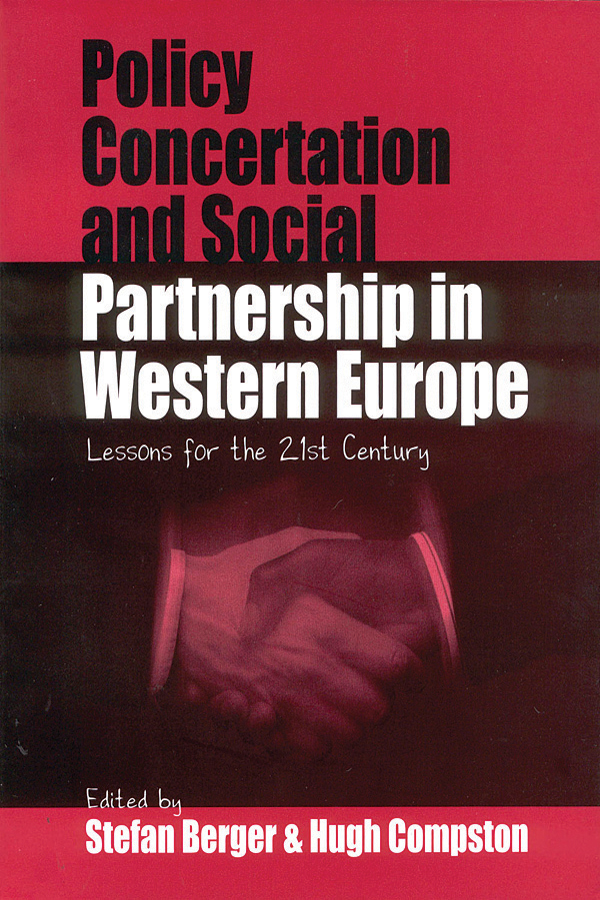
Policy Concertation and Social Partnership in Western Europe Policy concertation - the determination of public policy by means of agreements struck between governments, employers and trade unions - continues to thrive in Western Europe despite the impact of liberalizing trends that were expected to lead to its demise. This volume brings together a team of 23 experts with the aim to undertake paired historical and political studies of policy concertation in ten West European countries, which were then subjected to systematic comparative analysis. It shows that overall the incidence of broad policy concertation in Western Europe can be explained by the changing configurations of just three variables. POLITICAL SCIENCE,General
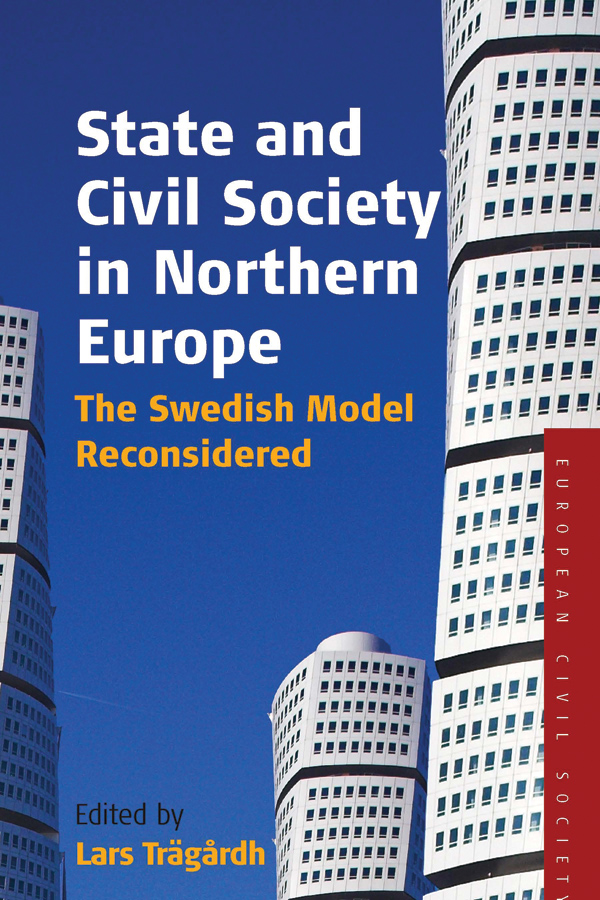
State and Civil Society in Northern Europe In the current neo-liberal political and economic climate, it is often suggested that a large and strong state stands in opposition to an autonomous and vibrant civil society. However, the simultaneous presence in Sweden of both a famously large public sector and an unusually vital civil society poses an interesting and important theoretical challenge to these views with serious political and policy implications. Studies show that in a comparative context Sweden scores very highly when it comes to the strength and vitality of its civil society as well as social capital, as measured in terms of trust, lack of corruption, and membership of voluntary associations. The “Swedish Model,†therefore, offers important insights into the dynamics of state and civil society relations, which go against current trends of undermining the importance of the welfare state, and presents autonomous civic participation as the only way forward. POLITICAL SCIENCE,General

Plural Identities - Singular Narratives Northern Ireland is frequently characterized in terms of a "two traditions" paradigm, representing the conflict as being between two discrete cultures. Proceeding from an analysis of the historical and religious context, this study demonstrates the reductionist nature of the "two traditions" model, highlighting instead the complexity of ethnic identities and cultural traditions. It thus shows why attempts at reconciliation like the Good Friday Agreement of 1998, which seeks to promote the concept of a "parity of esteem" based on this identity model., are fraught with difficulties. Reflecting on the applicability of the concept of multiculturalism in the context of Northern Ireland, the author proposes a re-conceptualisation of Northern Irish culture along lines that steer clear of binary oppositions. From the Contents: 'Webs of Significance'; Dis-membering the Past; Divided by Common Cosmologies; A Discourse in Difference; The Process if 'Cruthinitude'; Un Unclaimed Tradition; Ethnic Nationality; The 'Fuzzy Frontier'; The 'Common Ground' POLITICAL SCIENCE,General

Keep the Men Alive 'The thing that haunts me most to this day is that blokes were dying and I could do bugger all about it - do you look after the bloke who you know is going to die or the bloke who's got a chance?' - Australian ex-POW doctor, 1999 During World War II, 22 000 Australian military personnel became prisoners of war under the Japanese military. Over three and a half years, 8000 died in captivity, in desperate conditions of forced labour, disease and starvation. Many of those who returned home after the war attributed their survival to the 106 Australian medical officers imprisoned alongside them. These doctors varied in age, background and experience, but they were united in their unfailing dedication to keeping as many of the men alive as possible. This is the story of those 106 doctors - their compassion, bravery and ingenuity - and their efforts in bringing back the 14 000 survivors. 'You are unfortunate in being prisoners of a country whose living standards are much lower than yours. You will often consider yourselves mistreated, while we think of you as being treated well.' - Japanese officer to Australian POWs, 1943 POLITICAL SCIENCE,General

The Lie That Binds Public support for the legal right to abortion in the United States is at an all-time high. Yet we're in the midst of an all-out assault on reproductive freedom, and Roe v. Wade is hanging on by a thread. The Lie that Binds is the indispensable account of how the formerly non-partisan, back-burner issue of abortion rights was reinvented as the sharp point of the spear for a much larger reactionary movement bent on maintaining control in a changing world. Written by NARAL Pro-Choice America President Ilyse Hogue with research by Ellie Langford, The Lie that Binds traces the evolution of some of the most dangerous and least understood forces in U.S. politics, offering an unflinchingly incisive analysis of the conservative political machinery designed to thwart social progress - all built around the foundational lie that their motivations are based in moral convictions about individual pregnancies. This book introduces the colorful cast of characters behind the Radical Right - from anti-ERA protestors to men's rights activists - and explains how conservative political operatives intentionally targeted abortion as a rallying cry for their followers as their other prejudices fell from favor. Abortion acted as a Trojan horse to move a deeply unpopular, regressive policy agenda. POLITICAL SCIENCE,General

War and Genocide This comprehensive introduction to the study of war and genocide presents a disturbing case that the potential for slaughter is deeply rooted in the political, economic, social and ideological relations of the modern world. Most accounts of war and genocide treat them as separate phenomena. This book thoroughly examines the links between these two most inhuman of human activities. It shows that the generally legitimate business of war and the monstrous crime of genocide are closely related. This is not just because genocide usually occurs in the midst of war, but because genocide is a form of war directed against civilian populations. The book shows how fine the line has been, in modern history, between ‘degenerate war’ involving the mass destruction of civilian populations, and ‘genocide’, the deliberate destruction of civilian groups as such. Written by one of the foremost sociological writers on war, War and Genocide has four main features: an original argument about the meaning and causes of mass killing in the modern world; a guide to the main intellectual resources – military, political and social theories – necessary to understand war and genocide; summaries of the main historical episodes of slaughter, from the trenches of the First World War to the Nazi Holocaust and the killing fields of Cambodia, Bosnia and Rwanda; practical guides to further reading, courses and websites. This book examines war and genocide together with their opposites, peace and justice. It looks at them from the standpoint of victims as well as perpetrators. It is an important book for anyone wanting to understand – and overcome – the continuing salience of destructive forces in modern society. POLITICAL SCIENCE,Genocide & War Crimes
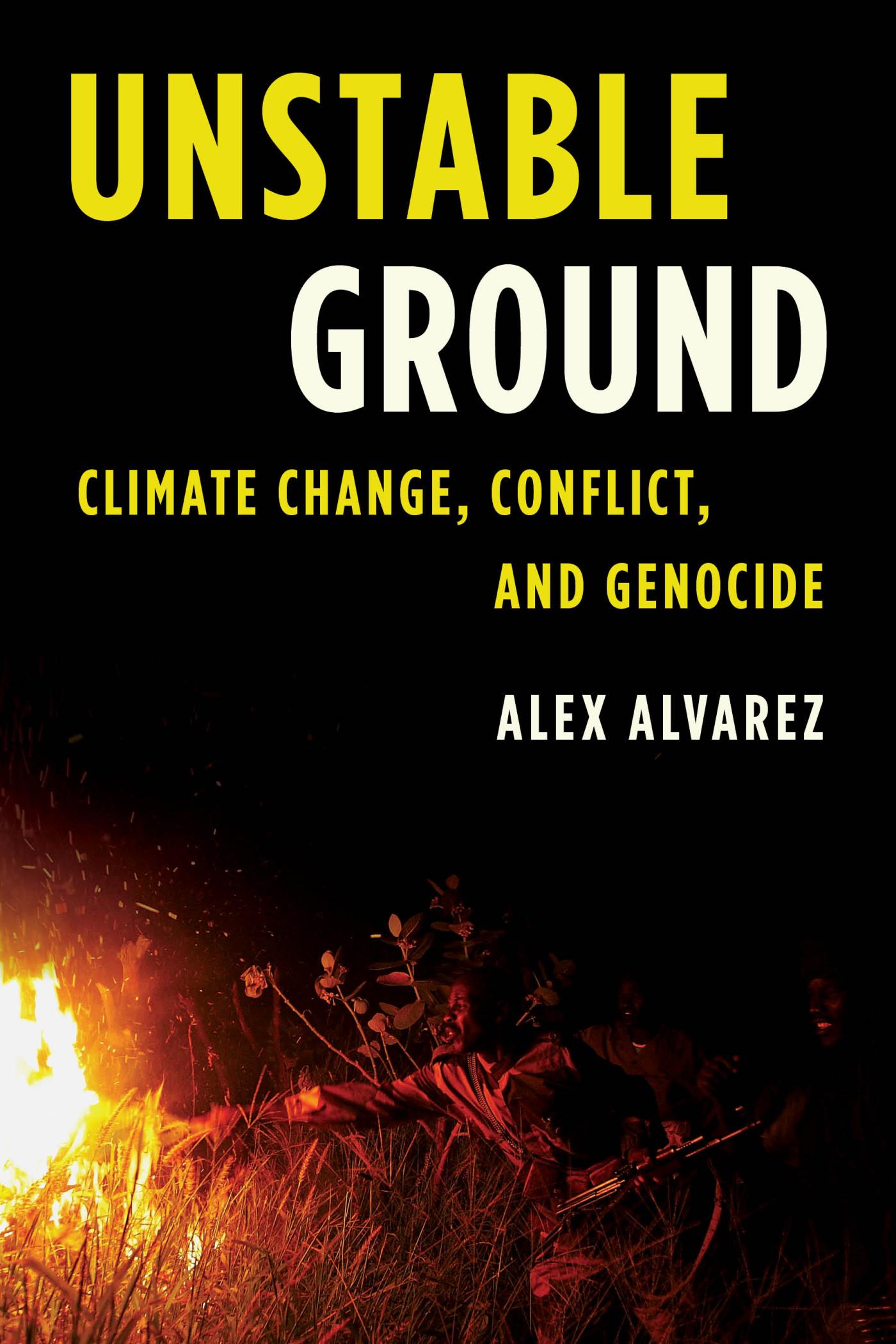
Unstable Ground Unstable Ground looks at the human impact of climate change and its potential to provoke some of the most troubling crimes against humanity—ethnic conflict, war, and genocide. The author examines the ways in which resources and global migration patterns will be impacted by climate change and create conditions conducive to violent conflict. POLITICAL SCIENCE,Genocide & War Crimes
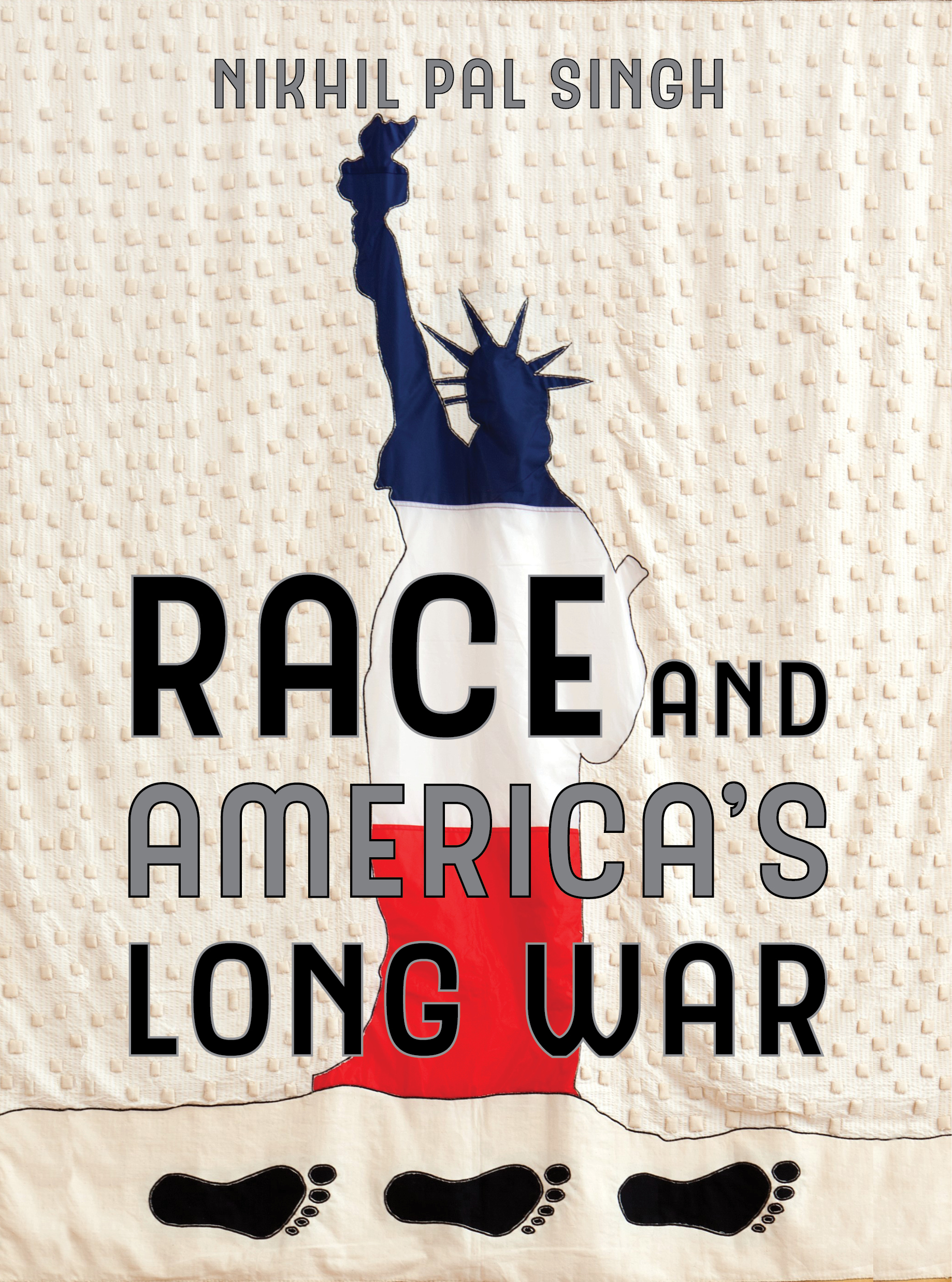
Race and America's Long War Donald Trump’s election to the U.S. presidency in 2016, which placed control of the government in the hands of the most racially homogenous, far-right political party in the Western world, produced shock and disbelief for liberals, progressives, and leftists globally. Yet most of the immediate analysis neglects longer-term accounting of how the United States arrived here. Race and America’s Long War examines the relationship between war, politics, police power, and the changing contours of race and racism in the contemporary United States. Nikhil Pal Singh argues that the United States’ pursuit of war since the September 11 terrorist attacks has reanimated a longer history of imperial statecraft that segregated and eliminated enemies both within and overseas. America’s territorial expansion and Indian removals, settler in-migration and nativist restriction, and African slavery and its afterlives were formative social and political processes that drove the rise of the United States as a capitalist world power long before the onset of globalization. Spanning the course of U.S. history, these crucial essays show how the return of racism and war as seemingly permanent features of American public and political life is at the heart of our present crisis and collective disorientation. POLITICAL SCIENCE,Genocide & War Crimes
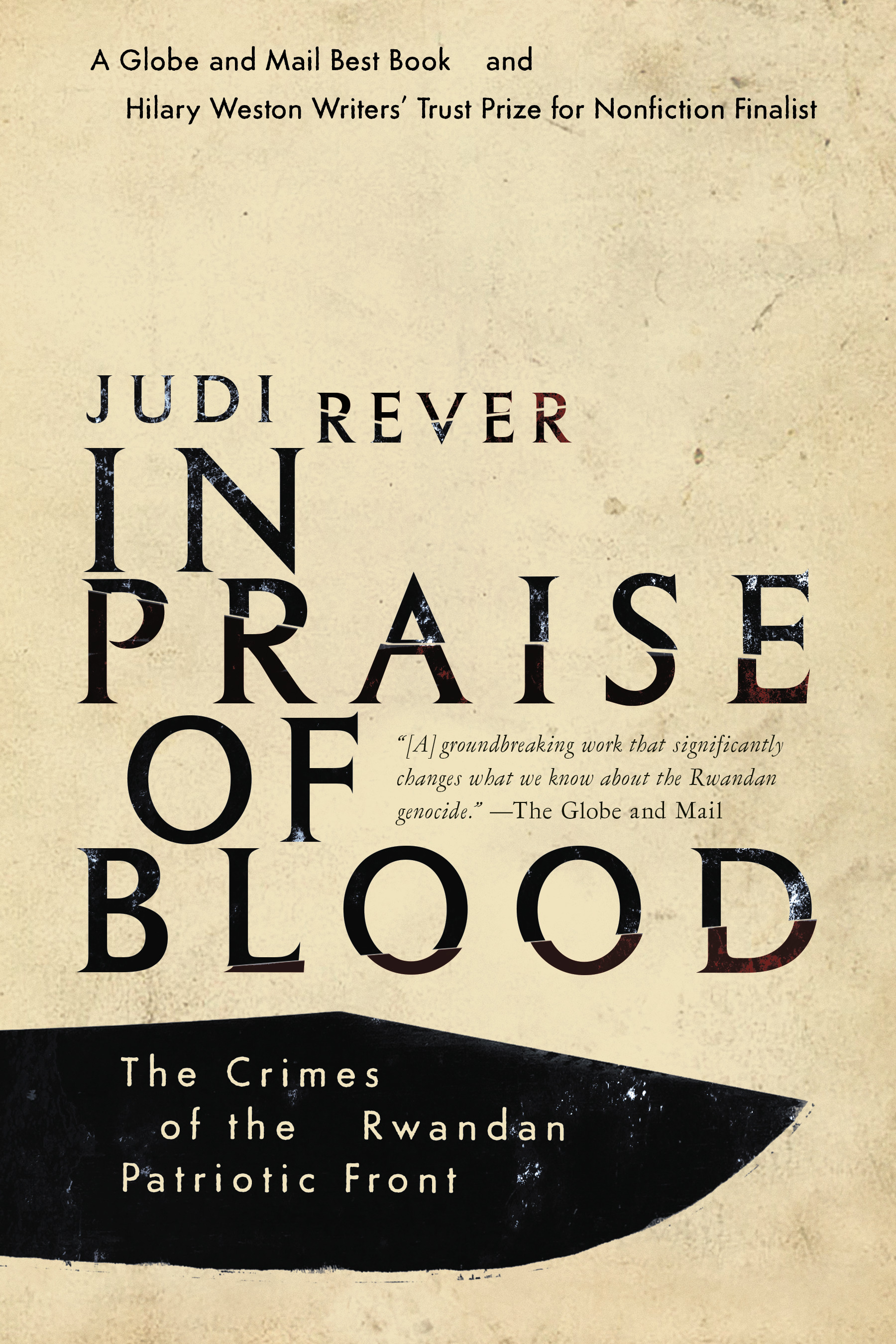
In Praise of Blood A stunning work of investigative reporting by a Canadian journalist who has risked her own life to bring us a deeply disturbing history of the Rwandan genocide that takes the true measure of Rwandan head of state Paul Kagame. Through unparalleled interviews with RPF defectors, former soldiers and atrocity survivors, supported by documents leaked from a UN court, Judi Rever brings us the complete history of the Rwandan genocide. Considered by the international community to be the saviours who ended the Hutu slaughter of innocent Tutsis, Kagame and his rebel forces were also killing, in quiet and in the dark, as ruthlessly as the Hutu genocidaire were killing in daylight. The reason why the larger world community hasn't recognized this truth? Kagame and his top commanders effectively covered their tracks and, post-genocide, rallied world guilt and played the heroes in order to attract funds to rebuild Rwanda and to maintain and extend the Tutsi sphere of influence in the region. Judi Rever, who has followed the story since 1997, has marshalled irrefutable evidence to show that Kagame's own troops shot down the presidential plane on April 6, 1994--the act that put the match to the genocidal flame. And she proves, without a shadow of doubt, that as Kagame and his forces slowly advanced on the capital of Kigali, they were ethnically cleansing the country of Hutu men, women and children in order that returning Tutsi settlers, displaced since the early '60s, would have homes and land. This book is heartbreaking, chilling and necessary. POLITICAL SCIENCE,Genocide & War Crimes
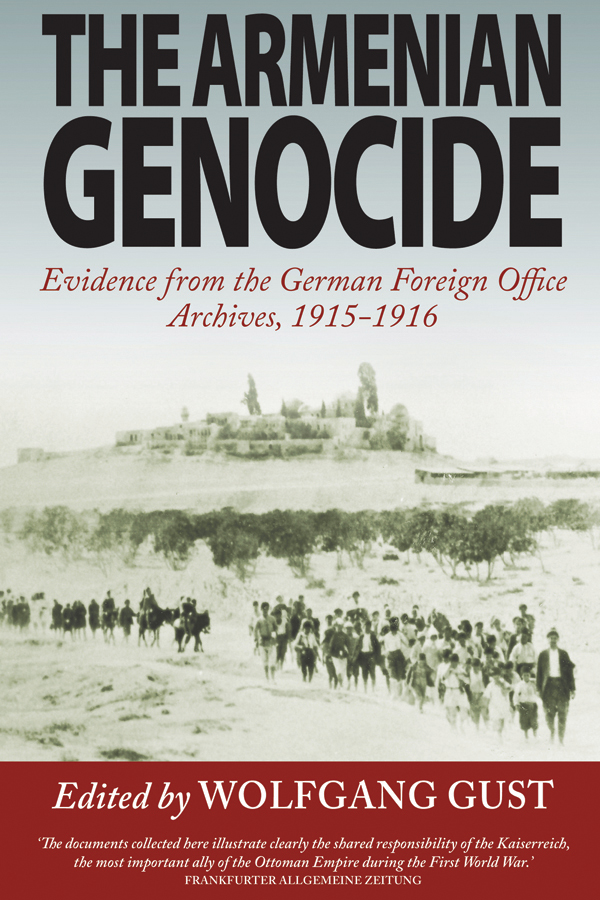
The Armenian Genocide In 1915, the Armenians were exiled from their land, and in the process of deportation 1.5 million of them were killed. The 1915-1916 annihilation of the Armenians was the archetype of modern genocide, in which a state adopts a specific scheme geared to the destruction of an identifiable group of its own citizens. Official German diplomatic documents are of great importance in understanding the genocide, as only Germany had the right to report day-by-day in secret code about the ongoing genocide. The motives, methods, and after-effects of the Armenian Genocide echoed strongly in subsequent cases of state-sponsored genocide. Studying the factors that went into the Armenian Genocide not only gives us an understanding of historical genocide, but also provides us with crucial information for the anticipation and possible prevention of future genocides. POLITICAL SCIENCE,Genocide & War Crimes

On the Path to Genocide Why did the Armenian genocide erupt in Turkey in 1915, only seven years after the Armenian minority achieved civil equality for the first time in the history of the Ottoman Empire? How can we explain the Rwandan genocide occurring in 1994, after decades of relative peace and even cooperation between the Hutu majority and the Tutsi minority? Addressing the question of how the risk of genocide develops over time, On the Path to Genocide contributes to a better understand why genocide occurs when it does. It provides a comprehensive and comparative historical analysis of the factors that led to the 1915 Armenian genocide and the 1994 genocide in Rwanda, using fresh sources and perspectives that yield new insights into the history of the Armenian and Rwandan peoples. Finally, it also presents new research into constraints that inhibit genocide, and how they can be utilized to attempt the prevention of genocide in the future. POLITICAL SCIENCE,Genocide & War Crimes

The Dark Side of Nation-States Why was there such a far-reaching consensus concerning the utopian goal of national homogeneity in the first half of the twentieth century? Ethnic cleansing is analyzed here as a result of the formation of democratic nation-states, the international order based on them, and European modernity in general. Almost all mass-scale population removals were rationally and precisely organized and carried out in cold blood, with revenge, hatred and other strong emotions playing only a minor role. This book not only considers the majority of population removals which occurred in Eastern Europe, but is also an encompassing, comparative study including Western Europe, interrogating the motivations of Western statesmen and their involvement in large-scale population removals. It also reaches beyond the European continent and considers the reverberations of colonial rule and ethnic cleansing in the former British colonies. POLITICAL SCIENCE,Genocide & War Crimes

Genocide and Settler Society Colonial Genocide has been seen increasingly as a stepping-stone to the European genocides of the twentieth century, yet it remains an under-researched phenomenon. This volume reconstructs instances of Australian genocide and for the first time places them in a global context. Beginning with the arrival of the British in 1788 and extending to the 1960s, the authors identify the moments of radicalization and the escalation of British violence and ethnic engineering aimed at the Indigenous populations, while carefully distinguishing between local massacres, cultural genocide, and genocide itself. These essays reflect a growing concern with the nature of settler society in Australia and in particular with the fate of the tens of thousands of children who were forcibly taken away from their Aboriginal families by state agencies. Long considered a relatively peaceful settlement, Australian society contained many of the pathologies that led to the exterminatory and eugenic policies of twentieth century Europe. POLITICAL SCIENCE,Genocide & War Crimes
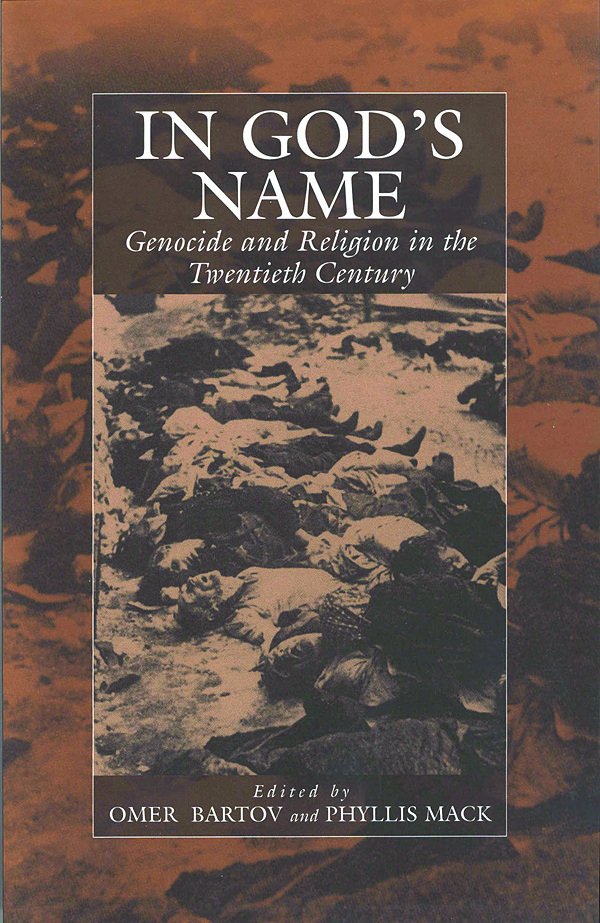
In God's Name Despite the widespread trends of secularization in the 20th century, religion has played an important role in several outbreaks of genocide since the First World War. And yet, not many scholars have looked either at the religious aspects of modern genocide, or at the manner in which religion has taken a position on mass killing. This collection of essays addresses this hiatus by examining the intersection between religion and state-organized murder in the cases of the Armenian, Jewish, Rwandan, and Bosnian genocides. Rather than a comprehensive overview, it offers a series of descrete, yet closely related case studies, that shed light on three fundamental aspects of this issue: the use of religion to legitimize and motivate genocide; the potential of religious faith to encourage physical and spiritual resistance to mass murder; and finally, the role of religion in coming to terms with the legacy of atrocity. POLITICAL SCIENCE,Genocide & War Crimes
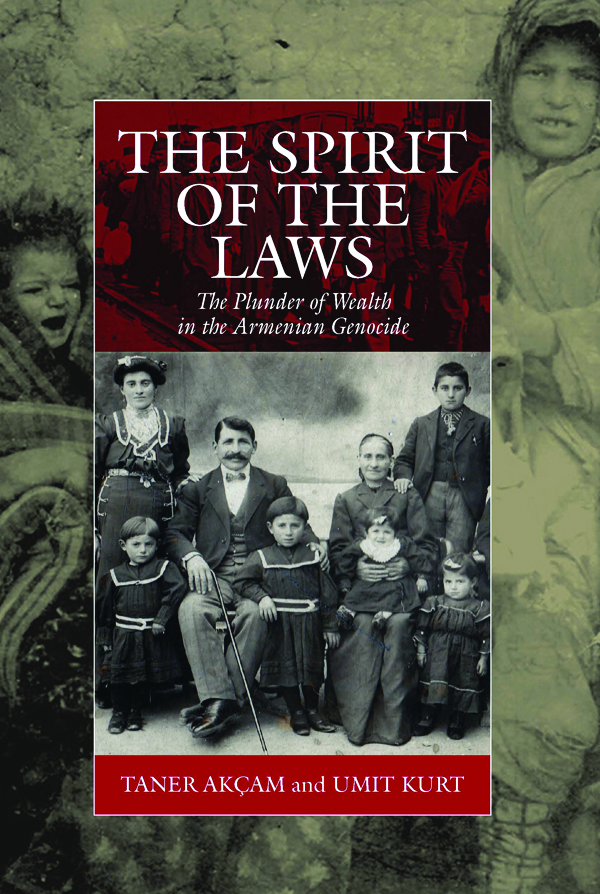
The Spirit of the Laws Pertinent to contemporary demands for reparations from Turkey is the relationship between law and property in connection with the Armenian Genocide. This book examines the confiscation of Armenian properties during the genocide and subsequent attempts to retain seized Armenian wealth. Through the close analysis of laws and treaties, it reveals that decrees issued during the genocide constitute central pillars of the Turkish system of property rights, retaining their legal validity, and although Turkey has acceded through international agreements to return Armenian properties, it continues to refuse to do so. The book demonstrates that genocides do not depend on the abolition of the legal system and elimination of rights, but that, on the contrary, the perpetrators of genocide manipulate the legal system to facilitate their plans. POLITICAL SCIENCE,Genocide & War Crimes
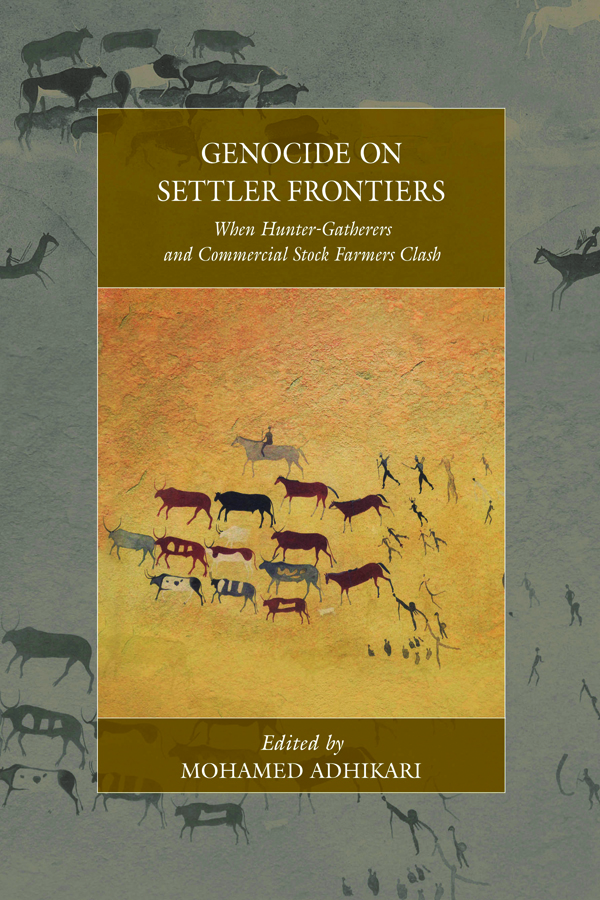
Genocide on Settler Frontiers European colonial conquest included many instances of indigenous peoples being exterminated. Cases where invading commercial stock farmers clashed with hunter-gatherers were particularly destructive, often resulting in a degree of dispossession and slaughter that destroyed the ability of these societies to reproduce themselves. The experience of aboriginal peoples in the settler colonies of southern Africa, Australia, North America, and Latin America bears this out. The frequency with which encounters of this kind resulted in the annihilation of forager societies raises the question of whether these conflicts were inherently genocidal, an issue not yet addressed by scholars in a systematic way. POLITICAL SCIENCE,Genocide & War Crimes
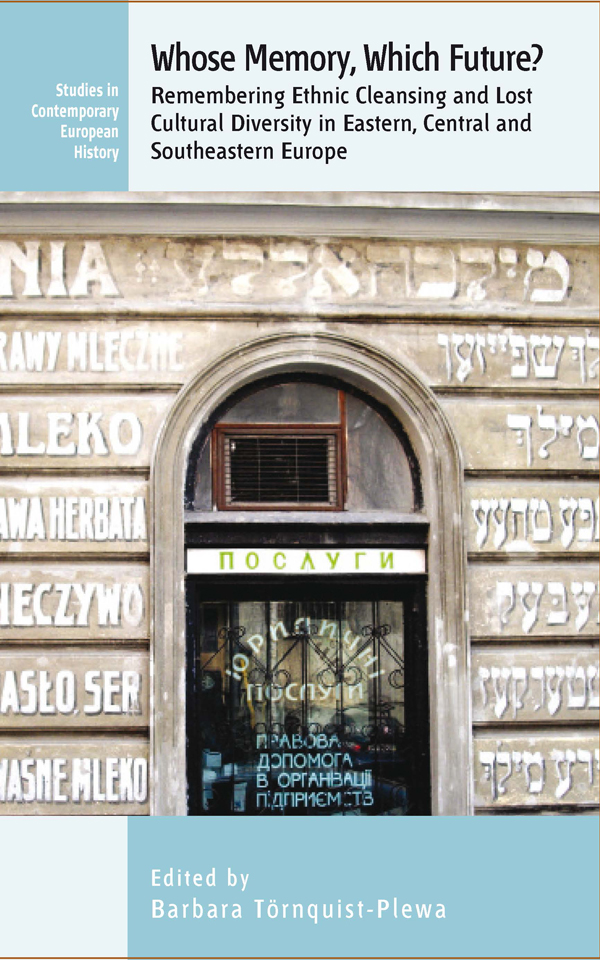
Whose Memory? Which Future? Scholars have devoted considerable energy to understanding the history of ethnic cleansing in Europe, reconstructing specific events, state policies, and the lived experiences of victims. Yet much less attention has been given to how these incidents persist in collective memory today. This volume brings together interdisciplinary case studies conducted in Central and Eastern European cities, exploring how present-day inhabitants “remember†past instances of ethnic cleansing, and how they understand the cultural heritage of groups that vanished in their wake. Together these contributions offer insights into more universal questions of collective memory and the formation of national identity. POLITICAL SCIENCE,Genocide & War Crimes

The Making of the Greek Genocide During and after World War I, over one million Ottoman Greeks were expelled from Turkey, a watershed moment in Greek history that resulted in hundreds of thousands of deaths. And while few dispute the expulsion’s tragic scope, it remains the subject of fierce controversy, as activists have fought for international recognition of an atrocity they consider comparable to the Armenian genocide. This book provides a much-needed analysis of the Greek genocide as cultural trauma. Neither taking the genocide narrative for granted nor dismissing it outright, Erik Sjöberg instead recounts how it emerged as a meaningful but contested collective memory with both nationalist and cosmopolitan dimensions. POLITICAL SCIENCE,Genocide & War Crimes
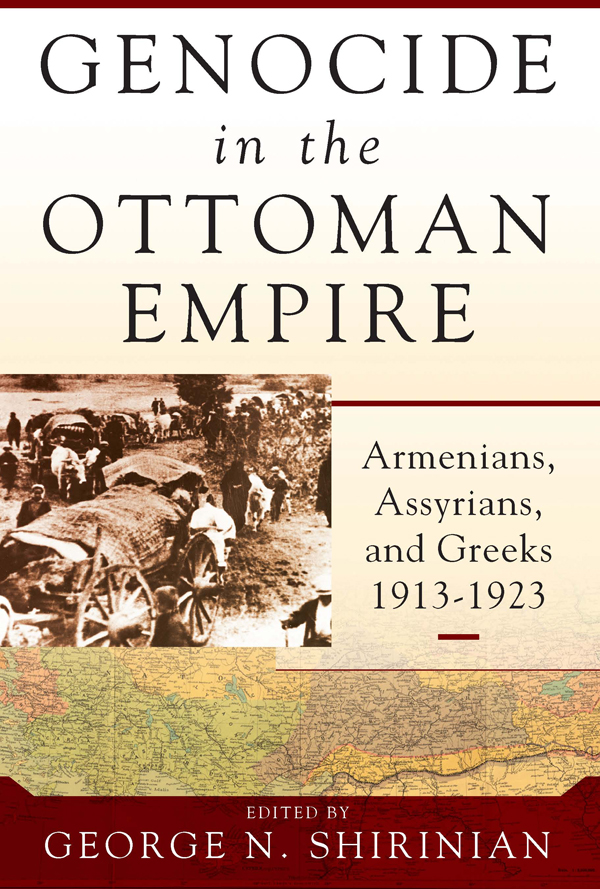
Genocide in the Ottoman Empire The final years of the Ottoman Empire were catastrophic ones for its non-Turkish, non-Muslim minorities. From 1913 to 1923, its rulers deported, killed, or otherwise persecuted staggering numbers of citizens in an attempt to preserve “Turkey for the Turks,†setting a modern precedent for how a regime can commit genocide in pursuit of political ends while largely escaping accountability. While this brutal history is most widely known in the case of the Armenian genocide, few appreciate the extent to which the Empire’s Assyrian and Greek subjects suffered and died under similar policies. This comprehensive volume is the first to broadly examine the genocides of the Armenians, Assyrians, and Greeks in comparative fashion, analyzing the similarities and differences among them and giving crucial context to present-day calls for recognition. POLITICAL SCIENCE,Genocide & War Crimes
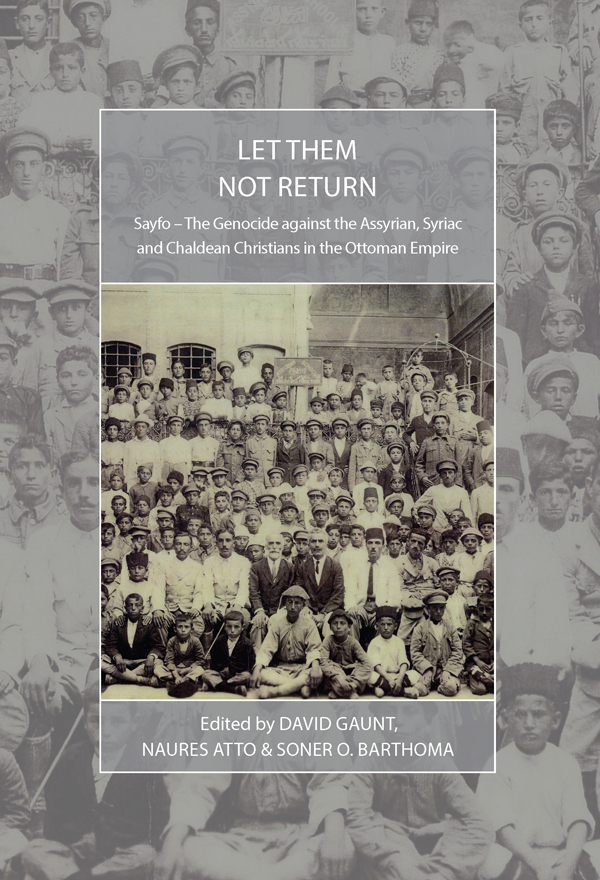
Let Them Not Return The mass killing of Ottoman Armenians is today widely recognized, both within and outside scholarly circles, as an act of genocide. What is less well known, however, is that it took place within a broader context of Ottoman violence against minority groups during and after the First World War. Among those populations decimated were the indigenous Christian Assyrians (also known as Syriacs or Chaldeans) who lived in the borderlands of present-day Turkey, Iran, and Iraq. This volume is the first scholarly edited collection focused on the Assyrian genocide, or “Sayfo†(literally, “sword†in Aramaic), presenting historical, psychological, anthropological, and political perspectives that shed much-needed light on a neglected historical atrocity. POLITICAL SCIENCE,Genocide & War Crimes
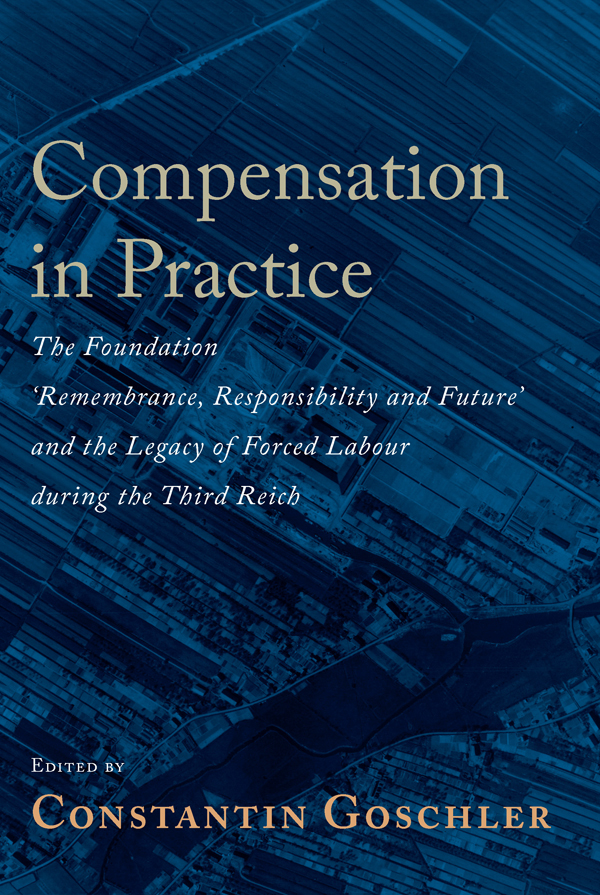
Compensation in Practice Founded in 2000, the German Foundation “Remembrance, Responsibility and Future†is one of the largest transitional justice initiatives in history: in cooperation with its international partner organizations, it has to date paid over 4 billion euros to nearly 1.7 million survivors of forced labour during the Nazi Era. This volume provides an unparalleled look at the Foundation’s creation, operations, and prospects after nearly two decades of existence, with valuable insights not just for historians but for a range of scholars, professionals, and others involved in human rights and reconciliation efforts. POLITICAL SCIENCE,Genocide & War Crimes
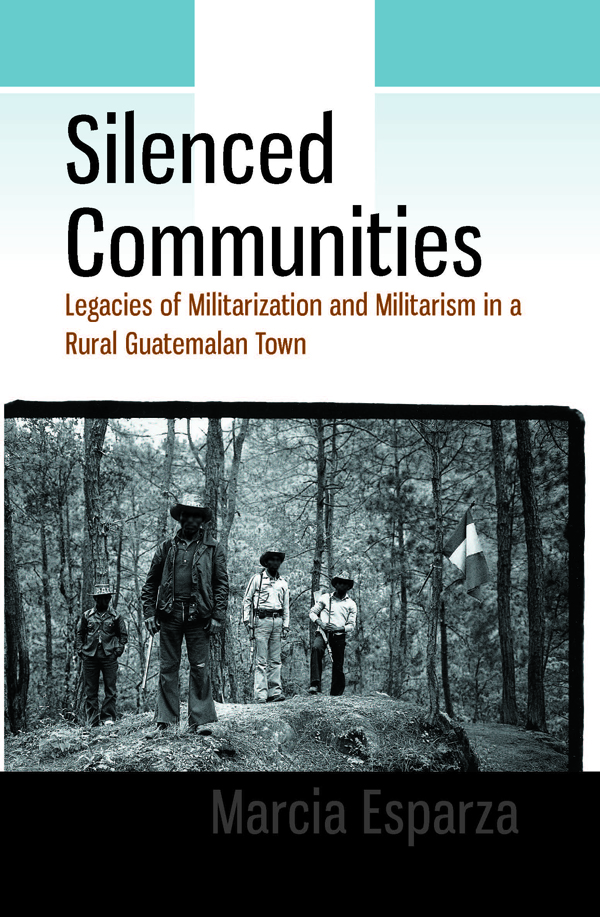
Silenced Communities Although the Guatemalan Civil War ended more than two decades ago, its bloody legacy continues to resonate even today. In Silenced Communities, author Marcia Esparza offers an ethnographic account of the failed demilitarization of the rural militia in the town of Santo Tomás Chichicastenango following the conflict. Combining insights from postcolonialism, subaltern studies, and theories of internal colonialism, Esparza explores the remarkable resilience of ideologies and practices engendered in the context of the Cold War, demonstrating how the lingering effects of grassroots militarization affect indigenous communities that continue to struggle with inequality and marginalization. POLITICAL SCIENCE,Genocide & War Crimes

Eyewitness to a Genocide Barnett addresses the ways in which the Rwandan genocide raises a warning about this age of humanitarianism and concludes by asking whether it is possible to build moral institutions. POLITICAL SCIENCE,Genocide & War Crimes
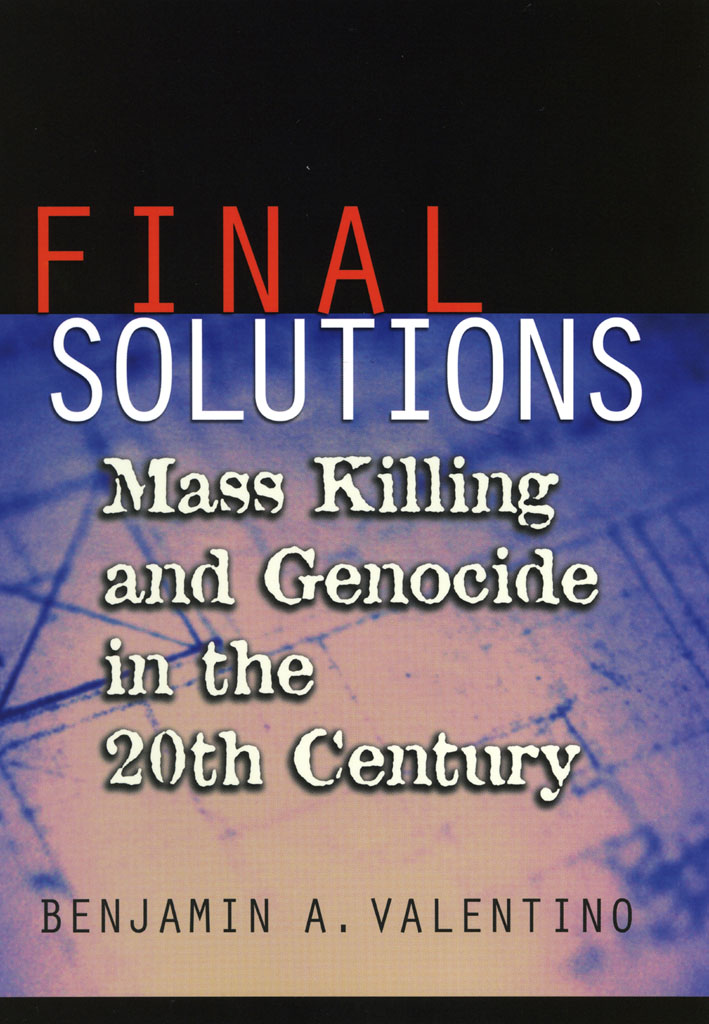
Final Solutions Benjamin A. Valentino finds that ethnic hatreds or discrimination, undemocratic systems of government, and dysfunctions in society play a much smaller role in mass killing and genocide than is commonly assumed. He shows that the impetus for mass... POLITICAL SCIENCE,Genocide & War Crimes
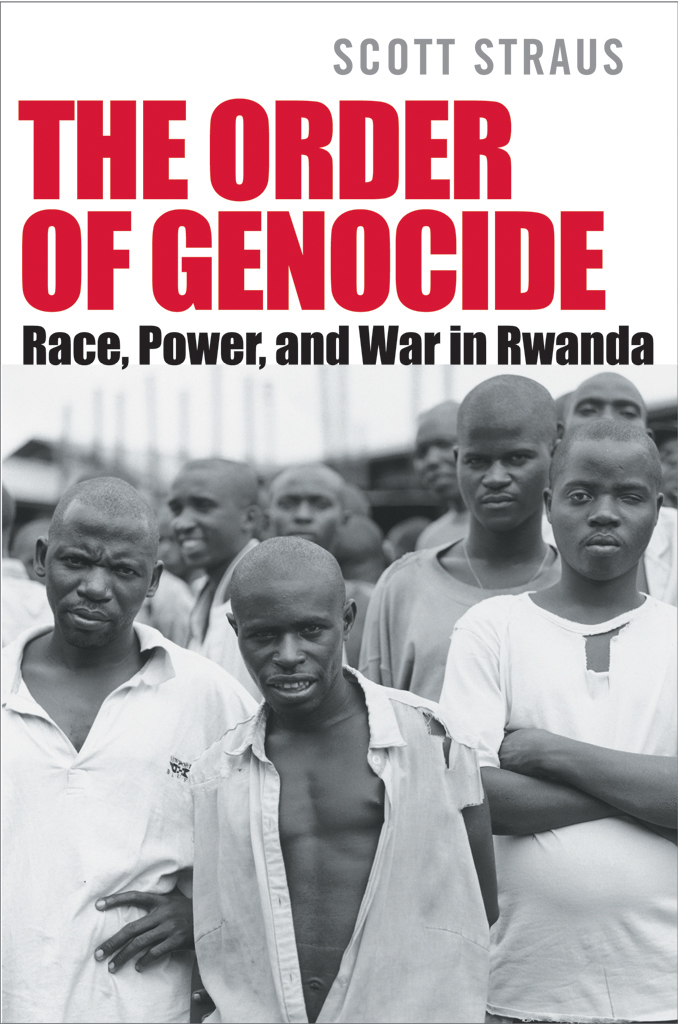
The Order of Genocide The Rwandan genocide has become a touchstone for debates about the causes of mass violence and the responsibilities of the international community. Yet a number of key questions about this tragedy remain unanswered: How did the violence spread from community to community and so rapidly engulf the nation? Why did individuals make decisions that led them to take up machetes against their neighbors? And what was the logic that drove the campaign of extermination? According to Scott Straus, a social scientist and former journalist in East Africa for several years (who received a Pulitzer Prize nomination for his reporting for the Houston Chronicle), many of the widely held beliefs about the causes and course of genocide in Rwanda are incomplete. They focus largely on the actions of the ruling elite or the inaction of the international community. Considerably less is known about how and why elite decisions became widespread exterminatory violence. Challenging the prevailing wisdom, Straus provides substantial new evidence about local patterns of violence, using original research—including the most comprehensive surveys yet undertaken among convicted perpetrators—to assess competing theories about the causes and dynamics of the genocide. Current interpretations stress three main causes for the genocide: ethnic identity, ideology, and mass-media indoctrination (in particular the influence of hate radio). Straus's research does not deny the importance of ethnicity, but he finds that it operated more as a background condition. Instead, Straus emphasizes fear and intra-ethnic intimidation as the primary drivers of the violence. A defensive civil war and the assassination of a president created a feeling of acute insecurity. Rwanda's unusually effective state was also central, as was the country's geography and population density, which limited the number of exit options for both victims and perpetrators. In conclusion, Straus steps back from the particulars of the Rwandan genocide to offer a new, dynamic model for understanding other instances of genocide in recent history—the Holocaust, Armenia, Cambodia, the Balkans—and assessing the future likelihood of such events. POLITICAL SCIENCE,Genocide & War Crimes
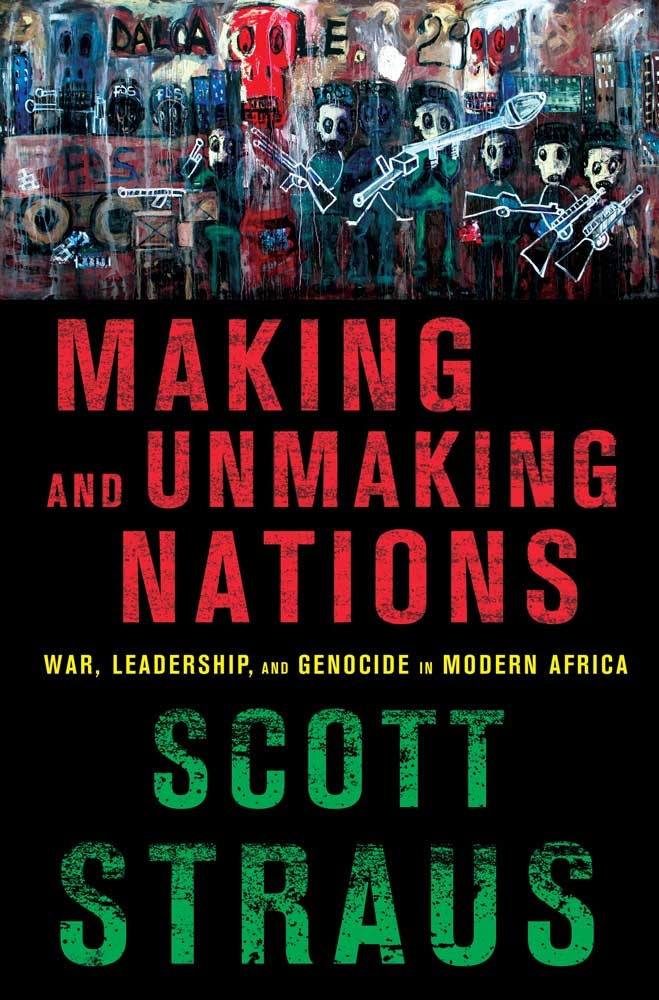
Making and Unmaking Nations Winner of the Grawmeyer Award for Ideas Improving World Order, 2018Winner of the Joseph Lepgold PrizeWinner of the Best Books in Conflict Studies (APSA)Winner of the Best Book in Human Rights (ISA) In Making and Unmaking Nations, Scott Straus seeks to explain why and how genocide takes place—and, perhaps more important, how it has been avoided in places where it may have seemed likely or even inevitable. To solve that puzzle, he examines postcolonial Africa, analyzing countries in which genocide occurred and where it could have but did not. Why have there not been other Rwandas? Straus finds that deep-rooted ideologies—how leaders make their nations—shape strategies of violence and are central to what leads to or away from genocide. Other critical factors include the dynamics of war, the role of restraint, and the interaction between national and local actors in the staging of campaigns of large-scale violence. Grounded in Straus's extensive fieldwork in contemporary Africa, the study of major twentieth-century cases of genocide, and the literature on genocide and political violence, Making and Unmaking Nations centers on cogent analyses of three nongenocide cases (Côte d'Ivoire, Mali, and Senegal) and two in which genocide took place (Rwanda and Sudan). Straus's empirical analysis is based in part on an original database of presidential speeches from 1960 to 2005. The book also includes a broad-gauge analysis of all major cases of large-scale violence in Africa since decolonization. Straus's insights into the causes of genocide will inform the study of political violence as well as giving policymakers and nongovernmental organizations valuable tools for the future. POLITICAL SCIENCE,Genocide & War Crimes
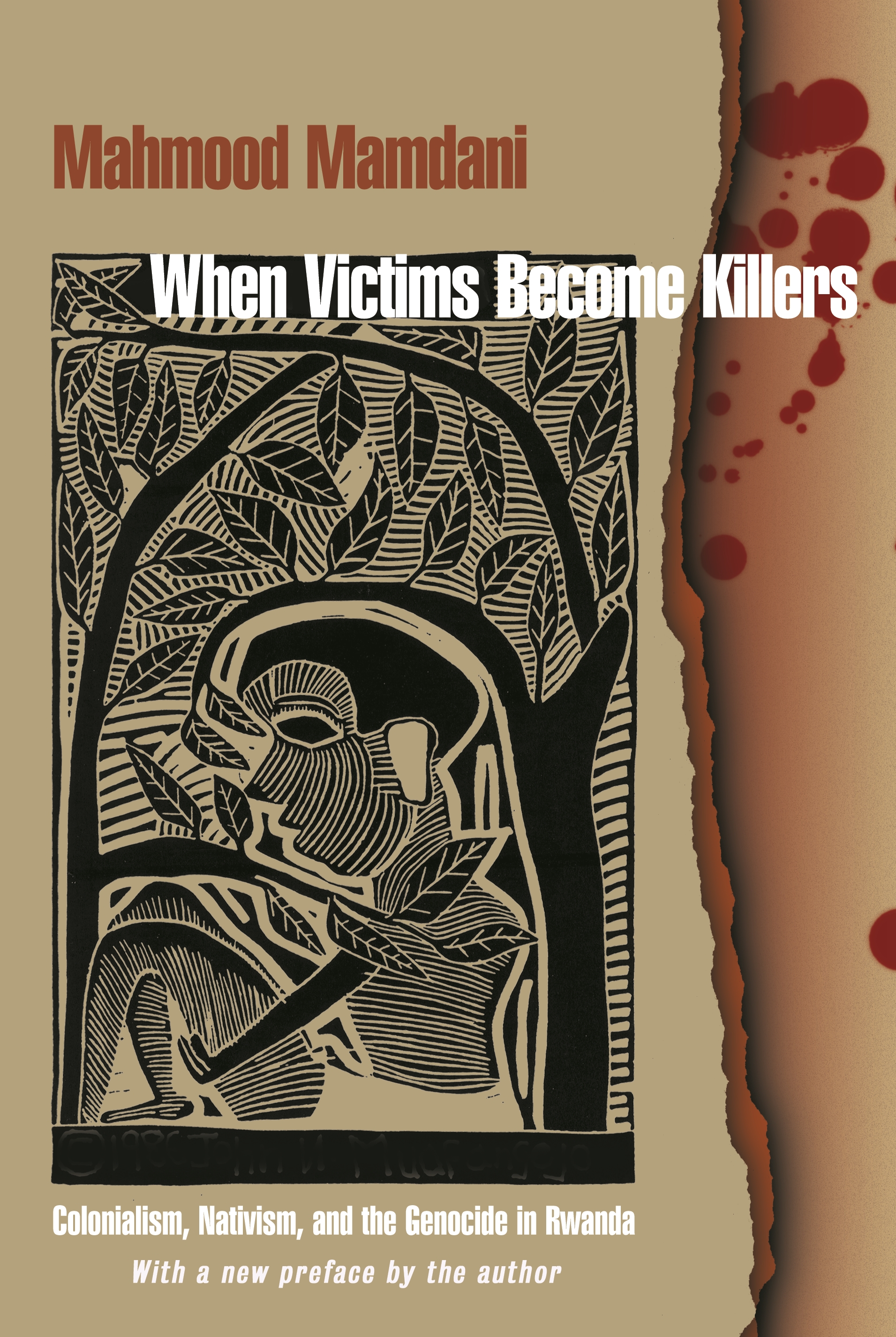
When Victims Become Killers An incisive look at the causes and consequences of the Rwandan genocide "When we captured Kigali, we thought we would face criminals in the state; instead, we faced a criminal population." So a political commissar in the Rwanda Patriotic Front reflected after the 1994 massacre of as many as one million Tutsis in Rwanda. Underlying his statement was the realization that, though ordered by a minority of state functionaries, the slaughter was performed by hundreds of thousands of ordinary citizens, including judges, doctors, priests, and friends. Rejecting easy explanations of the Rwandan genocide as a mysterious evil force that was bizarrely unleashed, When Victims Become Killers situates the tragedy in its proper context. Mahmood Mamdani coaxes to the surface the historical, geographical, and political forces that made it possible for so many Hutus to turn so brutally on their neighbors. In so doing, Mamdani usefully broadens understandings of citizenship and political identity in postcolonial Africa and provides a direction for preventing similar future tragedies. POLITICAL SCIENCE,Genocide & War Crimes

Germany's Genocide of the Herero This study recounts the reasons why the order for the Herero genocide was very likely issued by the Kaiser himself, and why proof of this has not emerged before now. POLITICAL SCIENCE,Genocide & War Crimes
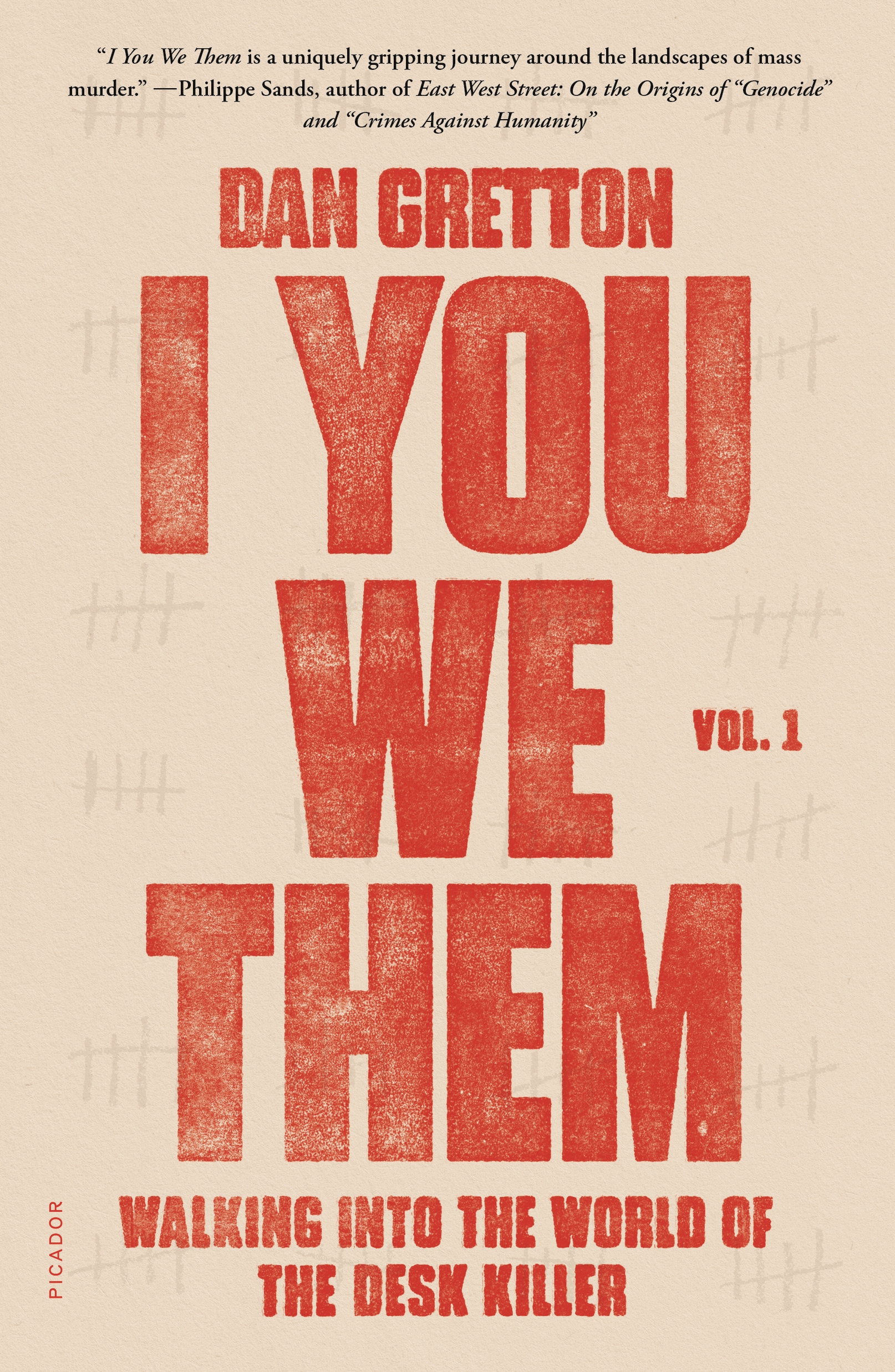
I You We Them "I You We Them is a uniquely gripping journey around the landscapes of mass murder." --Philippe Sands, author of East West Street: On the Origins of Genocide and Crimes against Humanity A Spectator (UK) Best Book of 2019 A landmark historical investigation into crimes against humanity and the nature of evil Vast and revelatory, Dan Gretton’s I You We Them is an unprecedented study of the perpetrators of crimes against humanity: the “desk killers†who ordered and directed some of the worst atrocities of the modern era. From AlbertSpeer’s complicity in Nazi barbarism to Royal Dutch Shell’s role in the murders of the Nigerian activist Ken Saro-Wiwa and the rest of the Ogoni Nine, Gretton probes the depths of the figure “who, by giving orders, uses paper or a phone or a computer to kill, instead of a gun.†Over the past twenty years, Gretton has interviewed survivors and perpetrators, and pored over archives and thousands of pages of testimony. His insight into the psychology of the desk killer is contextualized by the journey he took to penetrate it. Woven into the narrative are his contemplative interludes—perspectives gleaned during walks in the woods, reminiscences about a lost love, and considerations of timeless moral conundrums. The result is a genre-bending work steeped as much in personal reflection as it is in literature and historical and psychological illumination. A synthesis of history, reportage, and memoir, I You We Them is the first volume of a groundbreaking journal of discovery that bears witness to and reckons with the largest and most pressing questions before humanity. POLITICAL SCIENCE,Genocide & War Crimes
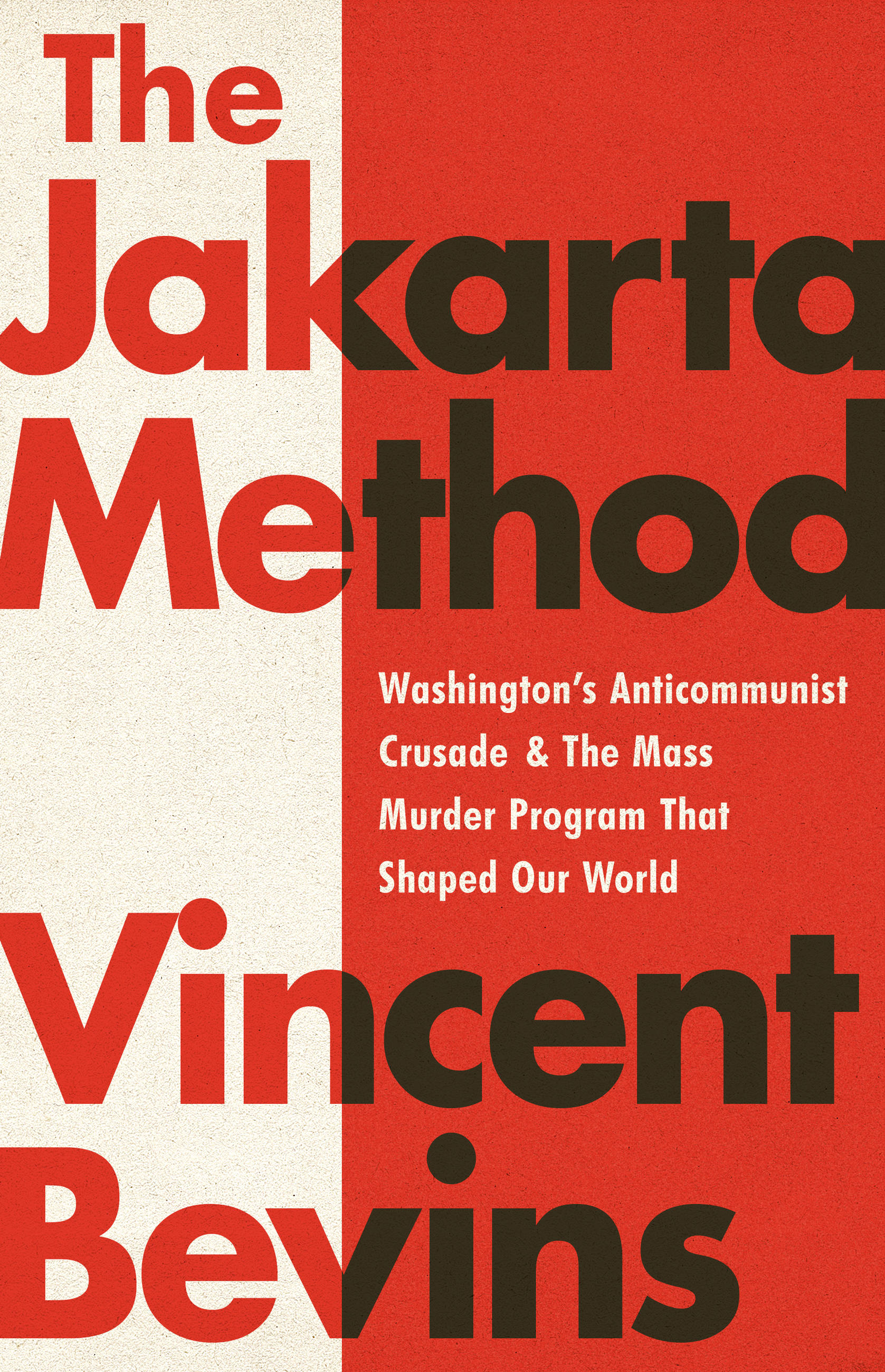
The Jakarta Method The hidden story of the wanton slaughter -- in Indonesia, Latin America, and around the world -- backed by the United States. In 1965, the U.S. government helped the Indonesian military kill approximately one million innocent civilians. This was one of the most important turning points of the twentieth century, eliminating the largest communist party outside China and the Soviet Union and inspiring copycat terror programs in faraway countries like Brazil and Chile. But these events remain widely overlooked, precisely because the CIA's secret interventions were so successful. In this bold and comprehensive new history, Vincent Bevins builds on his incisive reporting for the Washington Post, using recently declassified documents, archival research and eye-witness testimony collected across twelve countries to reveal a shocking legacy that spans the globe. For decades, it's been believed that parts of the developing world passed peacefully into the U.S.-led capitalist system. The Jakarta Method demonstrates that the brutal extermination of unarmed leftists was a fundamental part of Washington's final triumph in the Cold War. POLITICAL SCIENCE,Genocide & War Crimes
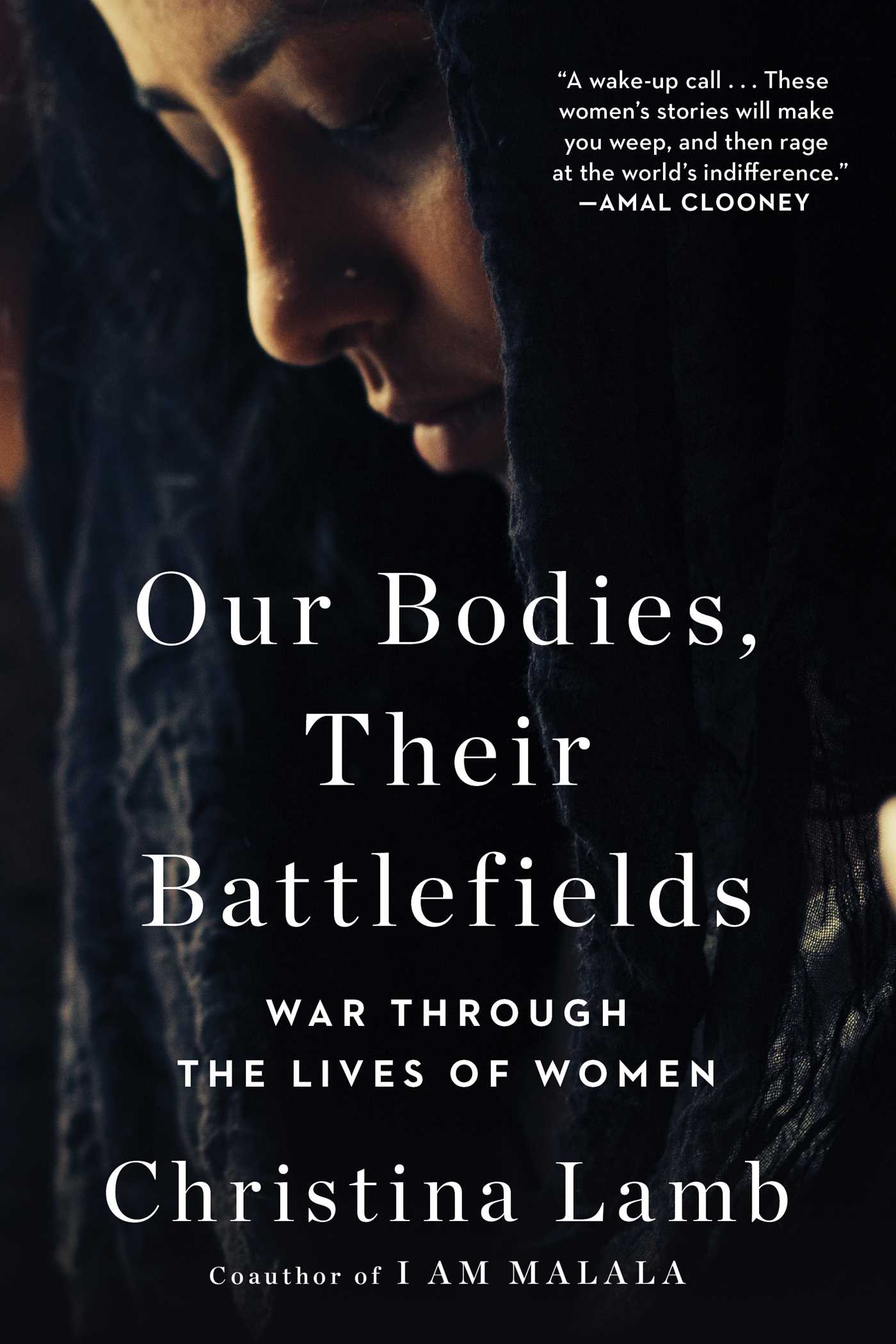
Our Bodies, Their Battlefields From Christina Lamb, the coauthor of the bestselling I Am Malala and an award-winning journalist—an essential, groundbreaking examination of how women experience war. In Our Bodies, Their Battlefields, longtime intrepid war correspondent Christina Lamb makes us witness to the lives of women in wartime. An award-winning war correspondent for twenty-five years (she’s never had a female editor) Lamb reports two wars—the “bang-bang†war and the story of how the people behind the lines live and survive. At the same time, since men usually act as the fighters, women are rarely interviewed about their experience of wartime, other than as grieving widows and mothers, though their experience is markedly different from that of the men involved in battle. Lamb chronicles extraordinary tragedy and challenges in the lives of women in wartime. And none is more devastating than the increase of the use of rape as a weapon of war. Visiting warzones including the Congo, Rwanda, Nigeria, Bosnia, and Iraq, and spending time with the Rohingya fleeing Myanmar, she records the harrowing stories of survivors, from Yazidi girls kept as sex slaves by ISIS fighters and the beekeeper risking his life to rescue them; to the thousands of schoolgirls abducted across northern Nigeria by Boko Haram, to the Congolese gynecologist who stitches up more rape victims than anyone on earth. Told as a journey, and structured by country, Our Bodies, Their Battlefields gives these women voice. We have made significant progress in international women’s rights, but across the world women are victimized by wartime atrocities that are rarely recorded, much less punished. The first ever prosecution for war rape was in 1997 and there have been remarkably few convictions since, as if rape doesn’t matter in the reckoning of war, only killing. Some courageous women in countries around the world are taking things in their own hands, hunting down the war criminals themselves, trying to trap them through Facebook. In this profoundly important book, Christina Lamb shines a light on some of the darkest parts of the human experience—so that we might find a new way forward. Our Bodies, Their Battlefields is as inspiring and empowering is as it is urgent, a clarion call for necessary change. POLITICAL SCIENCE,Genocide & War Crimes

The Holocaust/Genocide Template in Eastern Europe The Holocaust/Genocide Template in Eastern Europe discusses the “memory wars†in the course of the post-Communist re-narration of history since 1989 and the current authoritarian backlash. The book focuses specifically on how “mnemonic warriors†employ the “Holocaust template†and the concept of genocide in tendentious ways to justify radical policies and externalize the culpability for their international isolation and worsening social and economic circumstances domestically. The chapters analyze three dimensions: 1) the competing narratives of the “universalization of the Holocaust†as the negative icon of our era, on the one hand, and the “double genocide†paradigm, on the other, which focuses on “our own†national suffering under – allegedly “equally†evil – Nazism and Communism; 2) the juxtaposition of post-Communist Eastern Europe and Russia, reflected primarily in the struggle of the Baltic states and Ukraine to challenge Russian propaganda, a struggle that runs the risk of employing similarly distorting and propagandistic tropes; and 3) the post-Yugoslav rhetoric portraying one’s own group as “the new Jews†and one’s opponents in the wars of the 1990s as (akin to) “Nazisâ€. Surveying major battle sites in this “memory warâ€: memorial museums, monuments, film and the war over definitions and terminology in relevant public discourse, The Holocaust/Genocide Template in Eastern Europe will be of great interest to scholars of genocide, the Holocaust, historical memory and revisionism, and Eastern European Politics. This book was originally published as a special issue of the Journal of Genocide Research. POLITICAL SCIENCE,Genocide & War Crimes
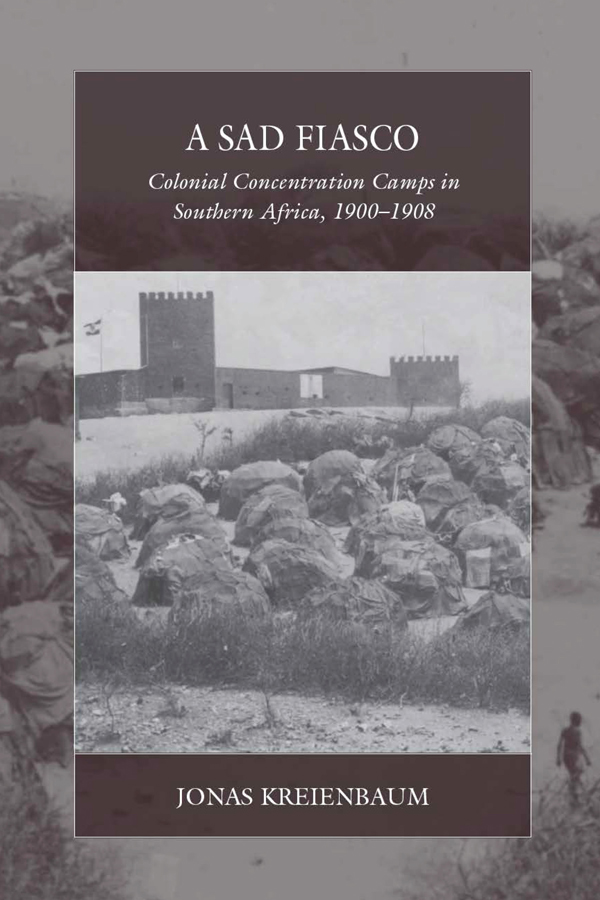
A Sad Fiasco Only in recent years has the history of European colonial concentration camps in Africa—in which thousands of prisoners died in appalling conditions—become widely known beyond a handful of specialists. Although they preceded the Third Reich by many decades, the camps’ newfound notoriety has led many to ask to what extent they anticipated the horrors of the Holocaust. Were they designed for mass killing, a misbegotten attempt at modernization, or something else entirely? A Sad Fiasco confronts this difficult question head-on, reconstructing the actions of colonial officials in both British South Africa and German South-West Africa as well as the experiences of internees to explore both the similarities and the divergences between the African camps and their Nazi-era successors. POLITICAL SCIENCE,Genocide & War Crimes
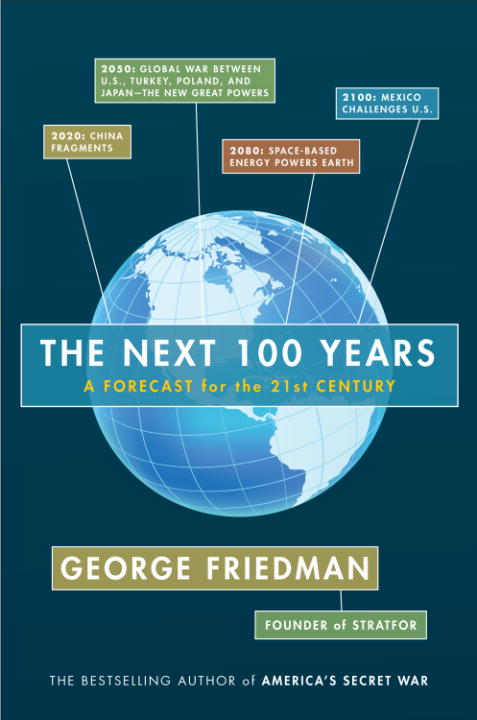
The Next 100 Years China fragments, a new Cold War with Russia, Mexcio challenges U.S., the new great powers Turkey, Poland and Japan. The Next 100 Years is a fascinating, eye-opening and often shocking look at what lies ahead for the U.S. and the world from one of our most incisive futurists. In his provocative book, George Friedman turns his eye on the future—offering a lucid, highly readable forecast of the changes we can expect around the world during the twenty-first century. He explains where and why future wars will erupt (and how they will be fought), which nations will gain and lose economic and political power, and how new technologies and cultural trends will alter the way we live in the new century. The Next 100 Years draws on a fascinating exploration of history and geopolitical patterns dating back hundreds of years. Friedman shows that we are now, for the first time in half a millennium, at the dawn of a new era—with changes in store, including: • The U.S.-Jihadist war will conclude—replaced by a second full-blown cold war with Russia.• China will undergo a major extended internal crisis, and Mexico will emerge as an important world power.• A new global war will unfold toward the middle of the century between the United States and an unexpected coalition from Eastern Europe, Eurasia, and the Far East; but armies will be much smaller and wars will be less deadly.• Technology will focus on space—both for major military uses and for a dramatic new energy resource that will have radical environmental implications.• The United States will experience a Golden Age in the second half of the century. Written with the keen insight and thoughtful analysis that has made George Friedman a renowned expert in geopolitics and forecasting, The Next 100 Years presents a fascinating picture of what lies ahead. POLITICAL SCIENCE,Geopolitics
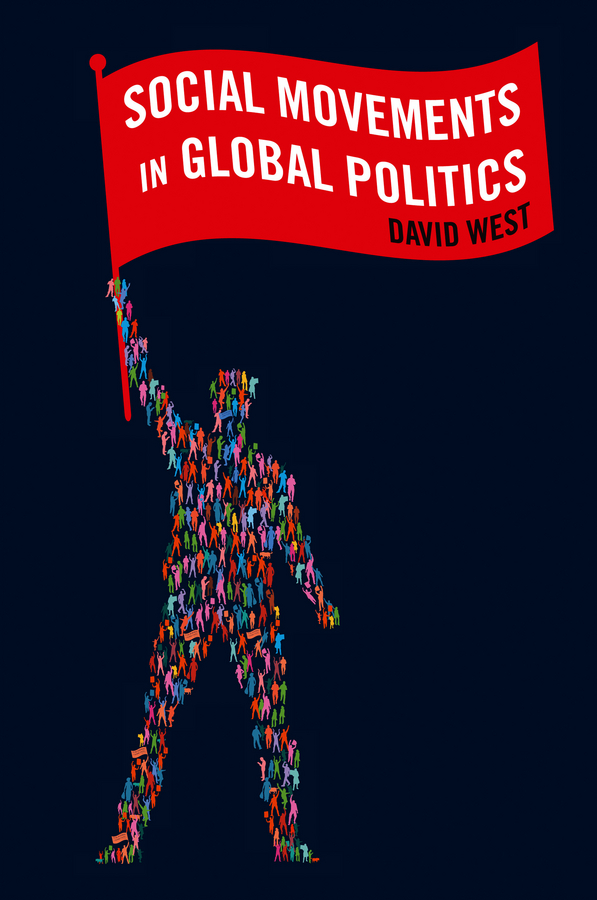
Social Movements in Global Politics Social Movements in Global Politics is a timely new account of the unconventional, ‘extra-institutional’ activities of social movements. In the face of impending global crises and stubborn conflicts, a conventional view of politics risks leaving us confused and fatalistic, feeling powerless because we are unaware of all that can be achieved by political means. By contrast, a variety of recent social movements, ranging from those of women, gays and lesbians and anti-racists, to environmentalists, the Occupy movement and the Arab Spring, demonstrate the enormous potential of political action beyond the institutional sphere of politics. At the same time, religious fundamentalists, racial supremacists and ultra-nationalists make clear that movements are not necessarily progressive and are often at odds with one another. West highlights the many ways in which national and global institutions depend on a broader context of extra-institutional action or what is, in effect, the formative dimension of politics. He explores some of the major contributions of social movements: from the genealogy of liberal democratic nation-states, sixties’ radicalism and the ‘new social movements’ to the politics of sexuality, gender and identity, the politicization of nature and climate, and alter-globalization. The book also considers current theoretical approaches and sets out the basis for a critical theory of social movements. This is a fresh and original account of social movements in politics and will be essential reading for any students and scholars interested in the challenges and the unpredictable potential of political action. POLITICAL SCIENCE,Geopolitics
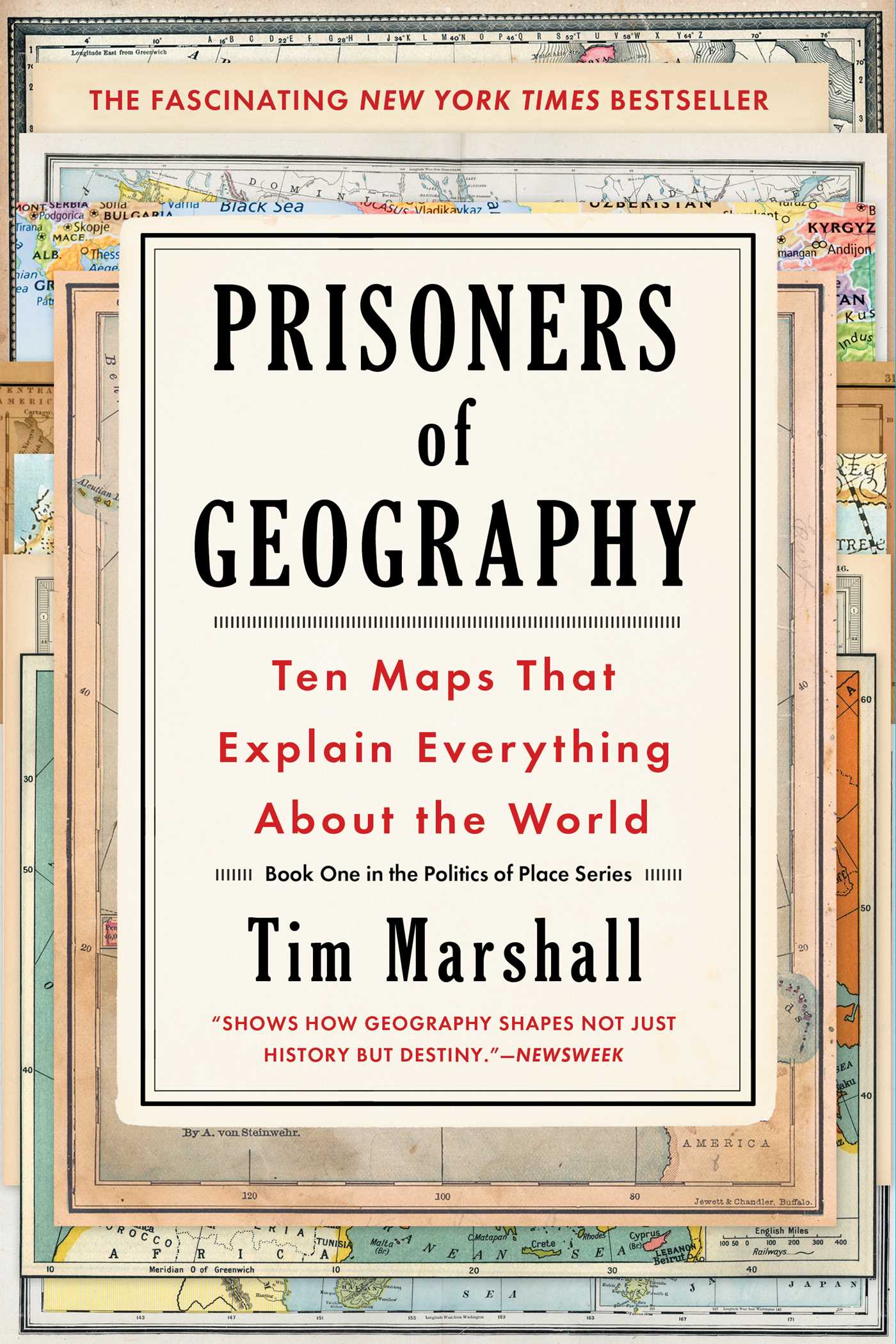
Prisoners of Geography In this New York Times bestseller, an award-winning journalist uses ten maps of crucial regions to explain the geo-political strategies of the world powers—“fans of geography, history, and politics (and maps) will be enthralled†(Fort Worth Star-Telegram). Maps have a mysterious hold over us. Whether ancient, crumbling parchments or generated by Google, maps tell us things we want to know, not only about our current location or where we are going but about the world in general. And yet, when it comes to geo-politics, much of what we are told is generated by analysts and other experts who have neglected to refer to a map of the place in question. All leaders of nations are constrained by geography. In “one of the best books about geopolitics†(The Evening Standard), now updated to include 2016 geopolitical developments, journalist Tim Marshall examines Russia, China, the US, Latin America, the Middle East, Africa, Europe, Japan, Korea, and Greenland and the Arctic—their weather, seas, mountains, rivers, deserts, and borders—to provide a context often missing from our political reportage: how the physical characteristics of these countries affect their strengths and vulnerabilities and the decisions made by their leaders. Offering “a fresh way of looking at maps†(The New York Times Book Review), Marshall explains the complex geo-political strategies that shape the globe. Why is Putin so obsessed with Crimea? Why was the US destined to become a global superpower? Why does China’s power base continue to expand? Why is Tibet destined to lose its autonomy? Why will Europe never be united? The answers are geographical. “In an ever more complex, chaotic, and interlinked world, Prisoners of Geography is a concise and useful primer on geopolitics†(Newsweek) and a critical guide to one of the major determining factors in world affairs. POLITICAL SCIENCE,Geopolitics
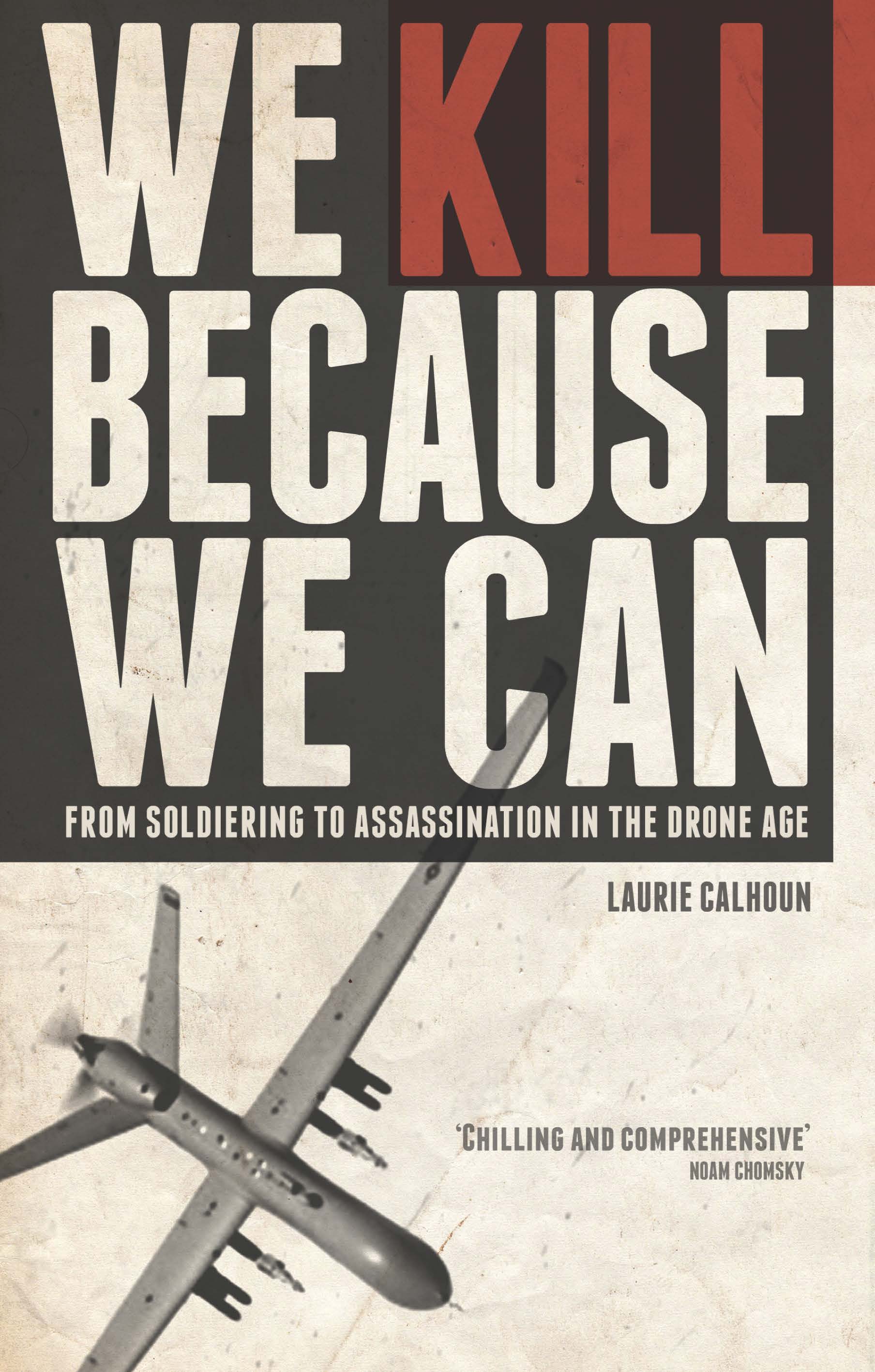
We Kill Because We Can A disturbing and controversial exposé of the ethics of remote-controlled warfare in the twenty-first century. POLITICAL SCIENCE,Geopolitics
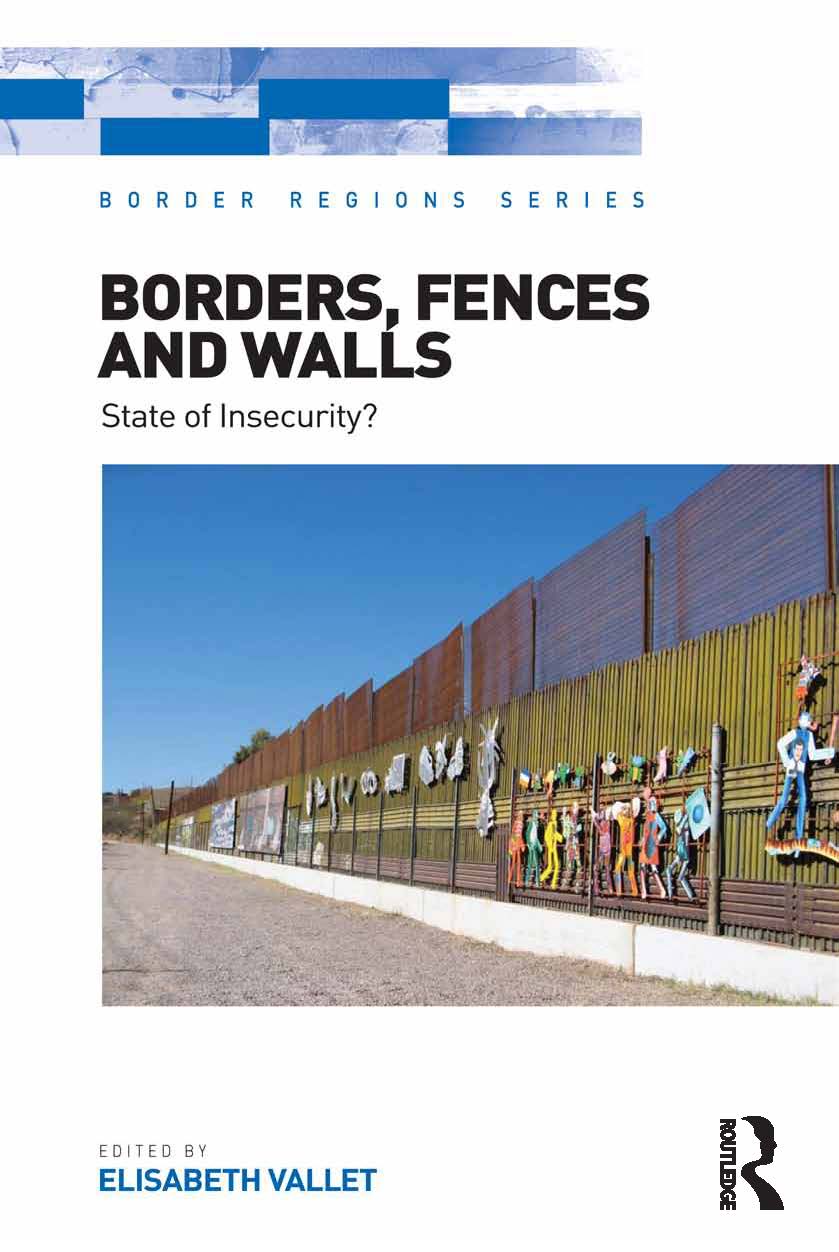
Borders, Fences and Walls Twenty years after the fall of the Berlin Wall, the question remains ’Do good fences still make good neighbours’? Since the Great Wall of China, the Antonine Wall, built in Scotland to support Hadrian's Wall, the Roman ’Limes’ or the Danevirk fence, the ’wall’ has been a constant in the protection of defined entities claiming sovereignty, East and West. But is the wall more than an historical relict for the management of borders? In recent years, the wall has been given renewed vigour in North America, particularly along the U.S.-Mexico border, and in Israel-Palestine. But the success of these new walls in the development of friendly and orderly relations between nations (or indeed, within nations) remains unclear. What role does the wall play in the development of security and insecurity? Do walls contribute to a sense of insecurity as much as they assuage fears and create a sense of security for those 'behind the line'? Exactly what kind of security is associated with border walls? This book explores the issue of how the return of the border fences and walls as a political tool may be symptomatic of a new era in border studies and international relations. Taking a multidisciplinary approach, this volume examines problems that include security issues ; the recurrence and/or decline of the wall; wall discourses ; legal approaches to the wall; the ’wall industry’ and border technology, as well as their symbolism, role, objectives and efficiency. POLITICAL SCIENCE,Geopolitics
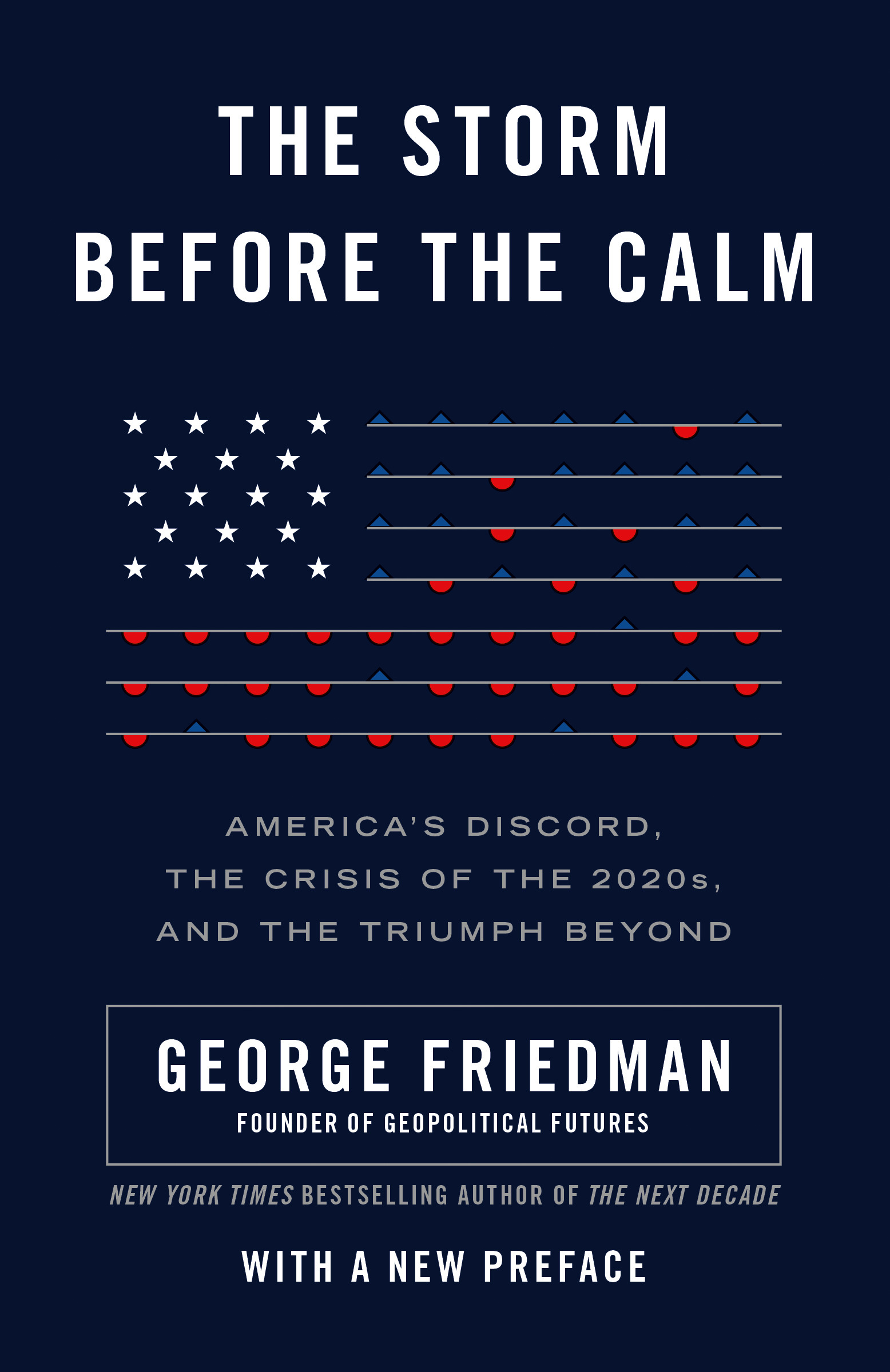
The Storm Before the Calm The master geopolitical forecaster and New York Times bestselling author of The Next 100 Years focuses on the United States, predicting how the 2020s will bring dramatic upheaval and reshaping of American government, foreign policy, economics, and culture. In his riveting new book, noted forecaster and bestselling author George Friedman turns to the future of the United States. Examining the clear cycles through which the United States has developed, upheaved, matured, and solidified, Friedman breaks down the coming years and decades in thrilling detail. American history must be viewed in cycles—particularly, an eighty-year "institutional cycle" that has defined us (there are three such examples—the Revolutionary War/founding, the Civil War, and World War II), and a fifty-year "socio-economic cycle" that has seen the formation of the industrial classes, baby boomers, and the middle classes. These two major cycles are both converging on the late 2020s—a time in which many of these foundations will change. The United States will have to endure upheaval and possible conflict, but also, ultimately, increased strength, stability, and power in the world. Friedman's analysis is detailed and fascinating, and covers issues such as the size and scope of the federal government, the future of marriage and the social contract, shifts in corporate structures, and new cultural trends that will react to longer life expectancies. This new book is both provocative and entertaining. POLITICAL SCIENCE,Geopolitics
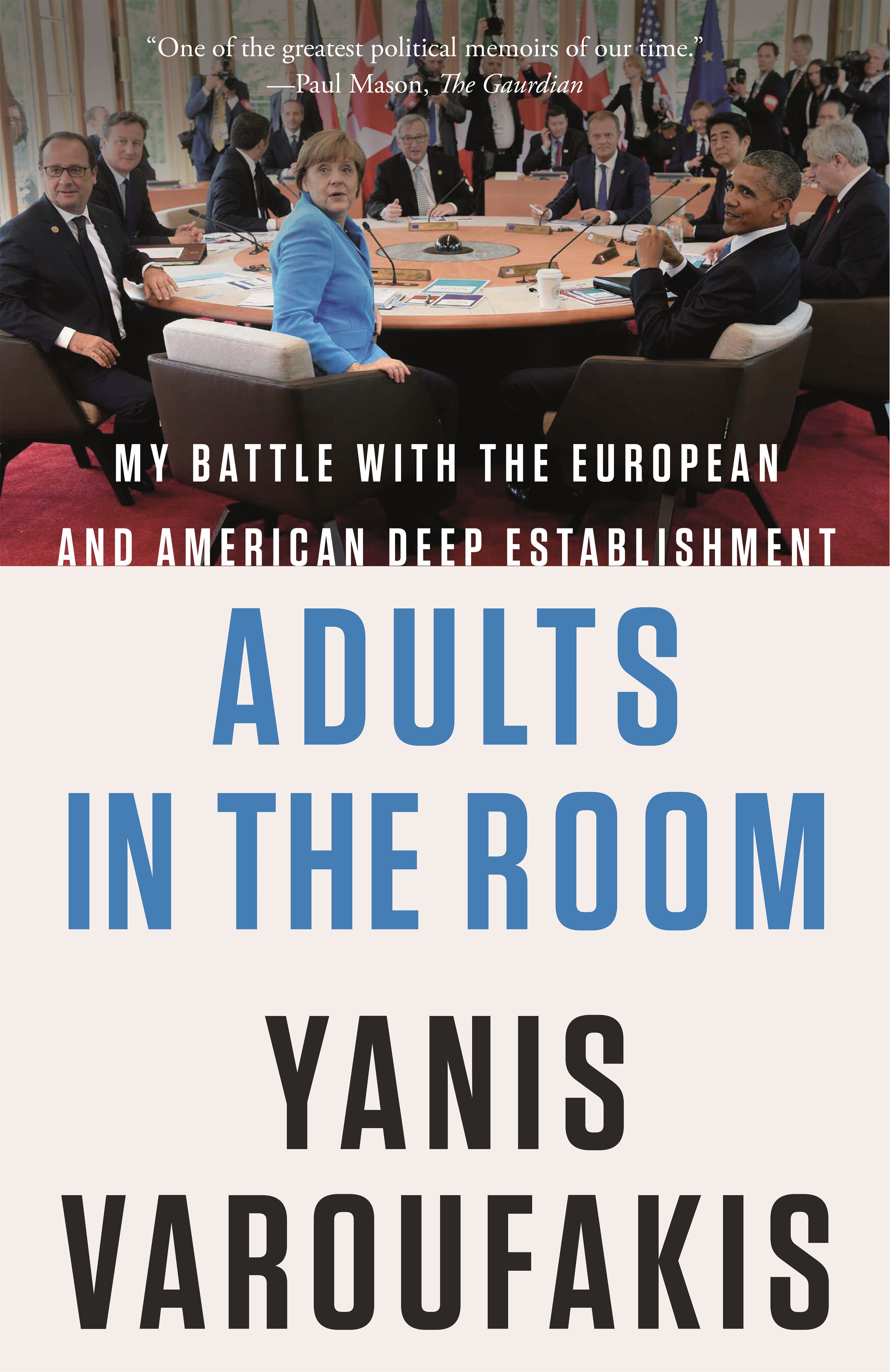
Adults in the Room The internationally bestselling memoir by an insurgent finance minister POLITICAL SCIENCE,Geopolitics
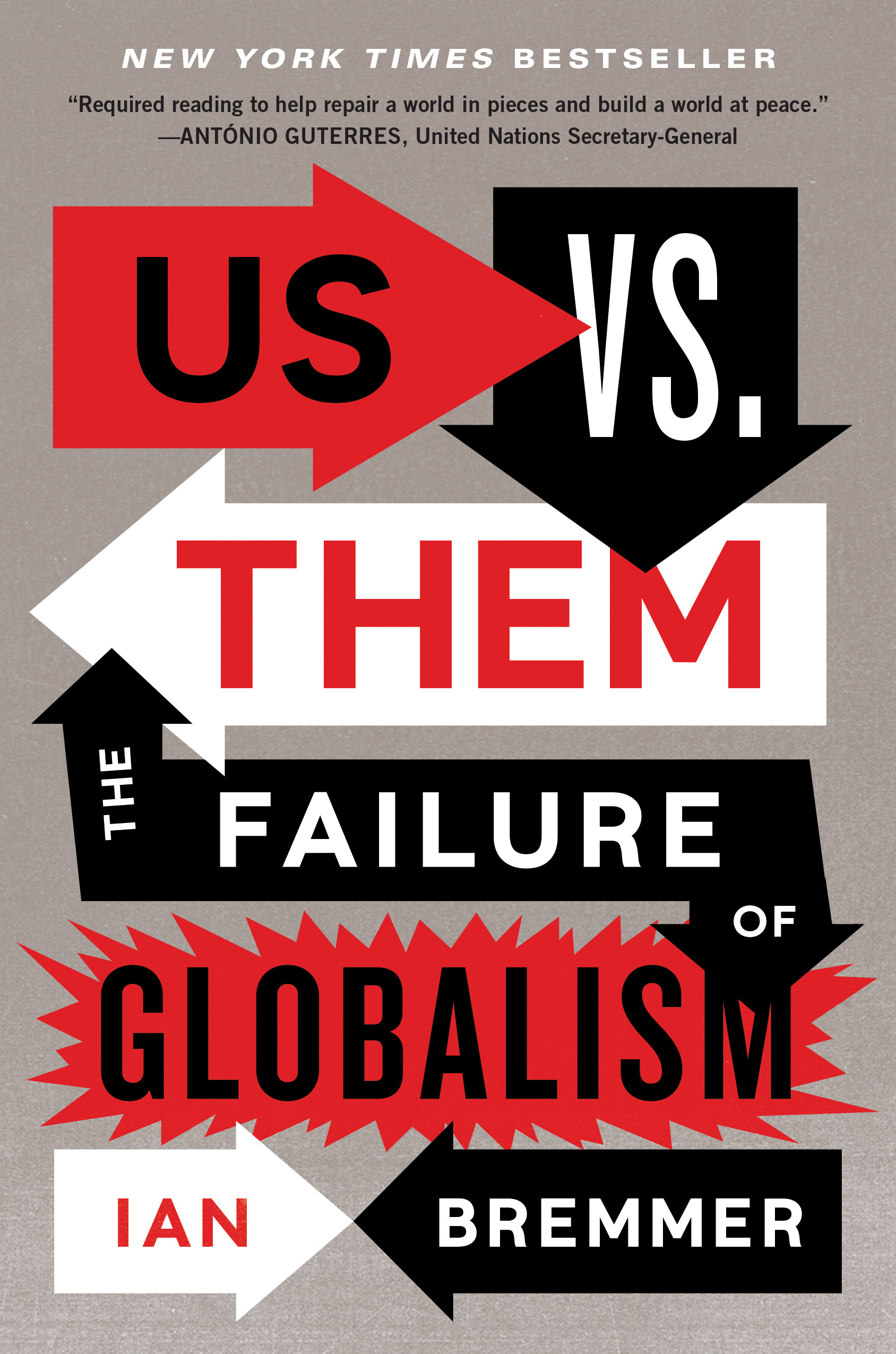
Us vs. Them New York Times bestseller "A cogent analysis of the concurrent Trump/Brexit phenomena and a dire warning about what lies ahead...a lucid, provocative book." --Kirkus Reviews Those who championed globalization once promised a world of winners, one in which free trade would lift all the world's boats, and extremes of left and right would give way to universally embraced liberal values. The past few years have shattered this fantasy, as those who've paid the price for globalism's gains have turned to populist and nationalist politicians to express fury at the political, media, and corporate elites they blame for their losses. The United States elected an anti-immigration, protectionist president who promised to "put America first" and turned a cold eye on alliances and treaties. Across Europe, anti-establishment political parties made gains not seen in decades. The United Kingdom voted to leave the European Union. And as Ian Bremmer shows in this eye-opening book, populism is still spreading. Globalism creates plenty of both winners and losers, and those who've missed out want to set things right. They've seen their futures made obsolete. They hear new voices and see new faces all about them. They feel their cultures shift. They don't trust what they read. They've begun to understand the world as a battle for the future that pits "us" vs. "them." Bremmer points to the next wave of global populism, one that hits emerging nations before they have fully emerged. As in Europe and America, citizens want security and prosperity, and they're becoming increasingly frustrated with governments that aren't capable of providing them. To protect themselves, many government will build walls, both digital and physical. For instance... * In Brazil and other fast-developing countries, civilians riot when higher expectations for better government aren't being met--the downside of their own success in lifting millions from poverty. * In Mexico, South Africa, Turkey, Indonesia, Egypt and other emerging states, frustration with government is on the rise and political battle lines are being drawn. * In China, where awareness of inequality is on the rise, the state is building a system to use the data that citizens generate to contain future demand for change * In India, the tools now used to provide essential services for people who've never had them can one day be used to tighten the ruling party's grip on power. When human beings feel threatened, we identify the danger and look for allies. We use the enemy, real or imagined, to rally friends to our side. This book is about the ways in which people will define these threats as fights for survival. It's about the walls governments will build to protect insiders from outsiders and the state from its people. And it's about what we can do about it. POLITICAL SCIENCE,Geopolitics

Assad or We Burn the Country From a Pulitzer Prize-nominated journalist specializing in the Middle East, this groundbreaking account of the Syrian Civil War reveals the never-before-published true story of a 21st-century humanitarian disaster. In spring 2011, Syrian President Bashar al-Assad turned to his friend and army commander, Manaf Tlass, for advice about how to respond to Arab Spring-inspired protests. Tlass pushed for conciliation but Assad decided to crush the uprising -- an act which would catapult the country into an eight-year long war, killing almost half a million and fueling terrorism and a global refugee crisis. Assad or We Burn the Country examines Syria's tragedy through the generational saga of the Assad and Tlass families, once deeply intertwined and now estranged in Bashar's bloody quest to preserve his father's inheritance. By drawing on his own reporting experience in Damascus and exclusive interviews with Tlass, Dagher takes readers within palace walls to reveal the family behind the destruction of a country and the chaos of an entire region. Dagher shows how one of the world's most vicious police states came to be and explains how a regional conflict extended globally, engulfing the Middle East and pitting the United States and Russia against one another. Timely, propulsive, and expertly reported, Assad or We Burn the Country is the definitive account of this global crisis, going far beyond the news story that has dominated headlines for years. POLITICAL SCIENCE,Geopolitics

Political Risk From New York Times bestselling author and former U.S. secretary of state Condoleezza Rice and Stanford University professor Amy B. Zegart comes an examination of the rapidly evolving state of political risk, and how to navigate it. The world is changing fast. Political risk-the probability that a political action could significantly impact a company's business-is affecting more businesses in more ways than ever before. A generation ago, political risk mostly involved a handful of industries dealing with governments in a few frontier markets. Today, political risk stems from a widening array of actors, including Twitter users, local officials, activists, terrorists, hackers, and more. The very institutions and laws that were supposed to reduce business uncertainty and risk are often having the opposite effect. In today's globalized world, there are no "safe" bets. POLITICAL RISK investigates and analyzes this evolving landscape, what businesses can do to navigate it, and what all of us can learn about how to better understand and grapple with these rapidly changing global political dynamics. Drawing on lessons from the successes and failures of companies across multiple industries as well as examples from aircraft carrier operations, NASA missions, and other unusual places, POLITICAL RISK offers a first-of-its-kind framework that can be deployed in any organization, from startups to Fortune 500 companies. Organizations that take a serious, systematic approach to political risk management are likely to be surprised less often and recover better. Companies that don't get these basics right are more likely to get blindsided. POLITICAL SCIENCE,Geopolitics

The Grand Strategy of the Habsburg Empire The Habsburg Empire’s grand strategy for outmaneuvering and outlasting stronger rivals in a complicated geopolitical world The Empire of Habsburg Austria faced more enemies than any other European great power. Flanked on four sides by rivals, it possessed few of the advantages that explain successful empires. Its army was not renowned for offensive prowess, its finances were often shaky, and its populace was fragmented into more than a dozen ethnicities. Yet somehow Austria endured, outlasting Ottoman sieges, Frederick the Great, and Napoleon. The Grand Strategy of the Habsburg Empire tells the story of how this cash-strapped, polyglot empire survived for centuries in Europe's most dangerous neighborhood without succumbing to the pressures of multisided warfare. Taking readers from the War of the Spanish Succession in the early 1700s to the Austro-Prussian War of 1866, A. Wess Mitchell argues that the Habsburgs succeeded not through offensive military power or great wealth but by developing strategies that manipulated the element of time in geopolitical competition. Unable to fight all their enemies at once, the Habsburgs learned to use the limited tools at their disposal—terrain, technology, and treaty allies—to sequence and stagger their conflicts, drive down the costs of empire, and concentrate scarce resources against the greatest threat of the moment. Rarely holding a grudge after war, they played the "long game" in geopolitics, corralling friend and foe alike into voluntarily managing the empire's lengthy frontiers and extending a benign hegemony across the turbulent lands of middle Europe. A study in adaptive statecraft, The Grand Strategy of the Habsburg Empire offers lessons on how to navigate a messy geopolitical map, stand firm without the advantage of military predominance, and prevail against multiple rivals. POLITICAL SCIENCE,Geopolitics
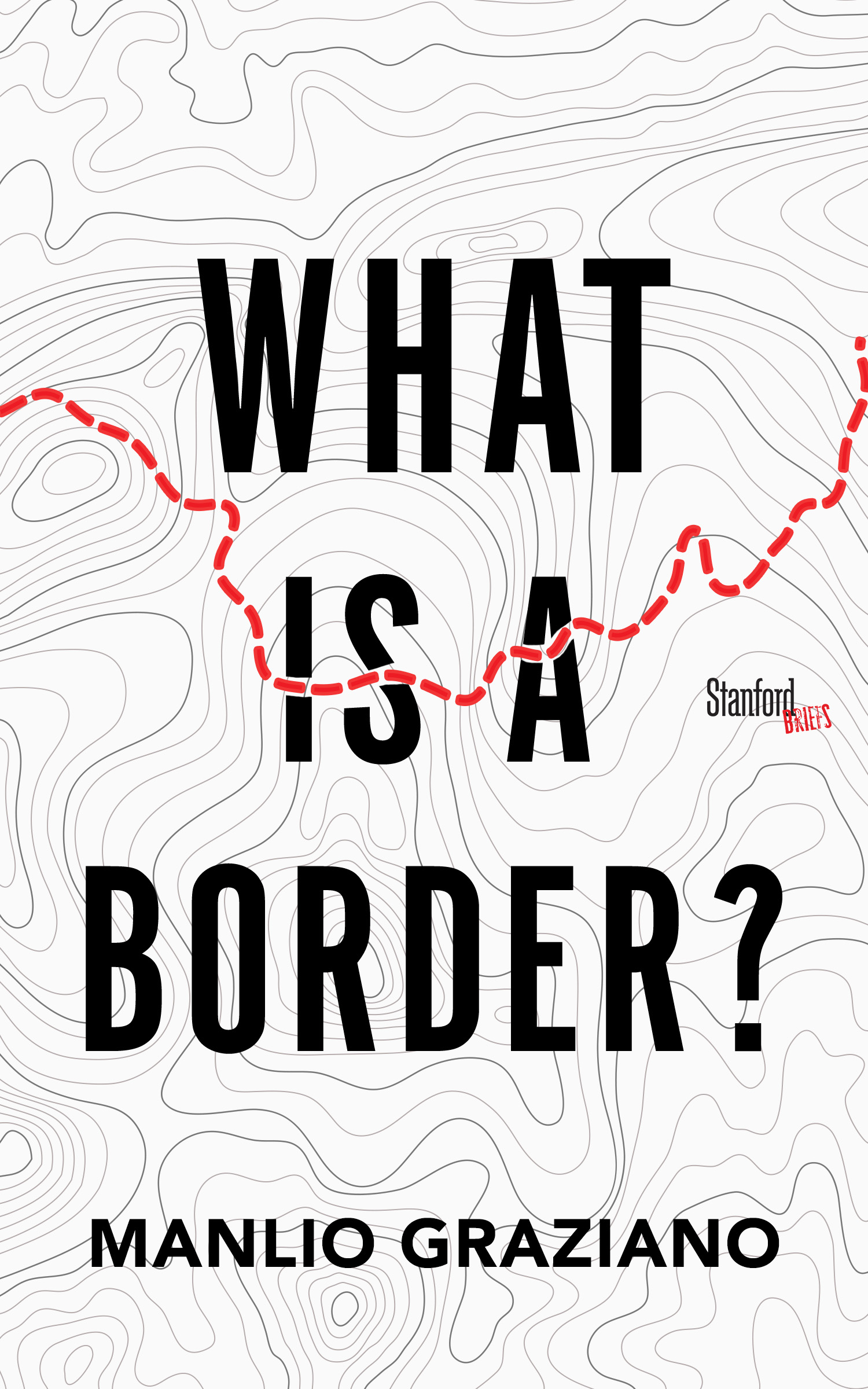
What Is a Border? Warning that the era of globalization is witnessing not the disappearance of borders but a return to them, this book analyzes and explains why borders have become a very topical subject in both domestic and international affairs today. POLITICAL SCIENCE,Geopolitics

The Nanny State Made Me 'The Nanny State Made Me is a vital piece of popular social history. It reminds us that a more equitable Britain once existed, and that if it happened once it can happen again - and might even be improved on this time round. I loved it.' Zadie Smith It was the spirit of our finest hour, the backbone of our post-war greatness, and it promoted some of the boldest and most brilliant schemes this isle has ever produced: it was the Welfare State, and it made you and I. But now it's under threat, and we need to save it. In this timely and provocative book, Stuart Maconie tells Britain's Welfare State story through his own history of growing up as a northern working class boy. What was so bad about properly funded hospitals, decent working conditions and affordable houses? And what was so wrong about student grants, free eye tests and council houses? And where did it all go so wrong? Stuart looks toward Britain's future, making an emotional case for believing in more than profit and loss; and championing a just, fairer society. POLITICAL SCIENCE,Geopolitics

House of Trump, House of Putin THE NEW YORK TIMES BESTSELLER “The story Unger weaves with those earlier accounts and his original reporting is fresh, illuminating and more alarming than the intelligence channel described in the Steele dossier.”—The Washington Post House of Trump, House of Putin offers the first comprehensive investigation into the decades-long relationship among Donald Trump, Vladimir Putin, and the Russian Mafia that ultimately helped win Trump the White House. It is a chilling story that begins in the 1970s, when Trump made his first splash in the booming, money-drenched world of New York real estate, and ends with Trump’s inauguration as president of the United States. That moment was the culmination of Vladimir Putin’s long mission to undermine Western democracy, a mission that he and his hand-selected group of oligarchs and Mafia kingpins had ensnared Trump in, starting more than twenty years ago with the massive bailout of a string of sensational Trump hotel and casino failures in Atlantic City. This book confirms the most incredible American paranoias about Russian malevolence. To most, it will be a hair-raising revelation that the Cold War did not end in 1991—that it merely evolved, with Trump’s apartments offering the perfect vehicle for billions of dollars to leave the collapsing Soviet Union. In House of Trump, House of Putin, Craig Unger methodically traces the deep-rooted alliance between the highest echelons of American political operatives and the biggest players in the frightening underworld of the Russian Mafia. He traces Donald Trump’s sordid ascent from foundering real estate tycoon to leader of the free world. He traces Russia’s phoenix like rise from the ashes of the post–Cold War Soviet Union as well as its ceaseless covert efforts to retaliate against the West and reclaim its status as a global superpower. Without Trump, Russia would have lacked a key component in its attempts to return to imperial greatness. Without Russia, Trump would not be president. This essential book is crucial to understanding the real powers at play in the shadows of today’s world. The appearance of key figures in this book—Paul Manafort, Michael Cohen, and Felix Sater to name a few—ring with haunting significance in the wake of Robert Mueller’s report and as others continue to close in on the truth. POLITICAL SCIENCE,Geopolitics
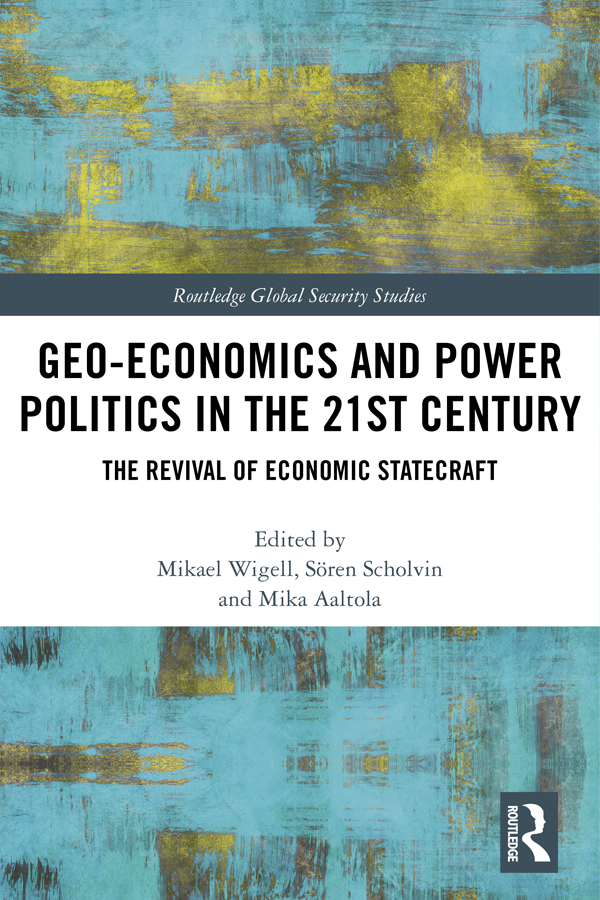
Geo-economics and Power Politics in the 21st Century Starting from the key concept of geo-economics, this book investigates the new power politics and argues that the changing structural features of the contemporary international system are recasting the strategic imperatives of foreign policy practice. States increasingly practice power politics by economic means. Whether it is about Iran’s nuclear programme or Russia’s annexation of Crimea, Western states prefer economic sanctions to military force. Most rising powers have also become cunning agents of economic statecraft. China, for instance, is using finance, investment and trade as means to gain strategic influence and embed its global rise. Yet the way states use economic power to pursue strategic aims remains an understudied topic in International Political Economy and International Relations. The contributions to this volume assess geo-economics as a form of power politics. They show how power and security are no longer simply coupled to the physical control of territory by military means, but also to commanding and manipulating the economic binds that are decisive in today’s globalised and highly interconnected world. Indeed, as the volume shows, the ability to wield economic power forms an essential means in the foreign policies of major powers. In so doing, the book challenges simplistic accounts of a return to traditional, military-driven geopolitics, while not succumbing to any unfounded idealism based on the supposedly stabilising effects of interdependence on international relations. As such, it advances our understanding of geo-economics as a strategic practice and as an innovative and timely analytical approach. This book will be of much interest to students of security studies, international political economy, foreign policy and International Relations in general. POLITICAL SCIENCE,Geopolitics

Blaming China American society is angrier, more fragmented, and more polarized than at any time since the Civil War. We harbor deep insecurities about our economic future, our place in the world, our response to terrorism, and our deeply dysfunctional government. Over the next several years, Benjamin Shobert says, these four insecurities will be perverted and projected onto China in an attempt to shift blame for errors entirely of our own making. These misdirections will be satisfying in the short term but will eventually destabilize the global world that businesses, consumers, and governments have taken for granted for the last forty years and will usher in an age of geopolitical uncertainty characterized by regional conflict and increasing economic dislocation. Shobert, a senior associate at the National Bureau of Asian Research, explores how America’s attitudes toward China have changed and how our economic anxieties and political dysfunction have laid the foundation for turning our collective frustrations away from acknowledging the consequences of our own poor decisions. Shobert argues that unless we address these problems, a disastrous chapter in American life is right around the corner, one in which Americans will decide that conflict with China is the only sensible option. After framing how the American public thinks about China, Shobert offers two alternative paths forward. He proposes steps that businesses, governments, and individuals can take to potentially stop and reverse America’s path to a dystopian future. POLITICAL SCIENCE,Geopolitics

Clear Bright Future A passionate defence of humanity and a work of radical optimism from the international bestselling author of Postcapitalism How do we preserve what makes us human in an age of uncertainty? Are we now just consumers shaped by market forces? A sequence of DNA? A collection of base instincts? Or will we soon be supplanted by algorithms and A.I. anyway? In Clear Bright Future, Paul Mason calls for a radical, impassioned defence of the human being, our universal rights and freedoms and our power to change the world around us. Ranging from economics to Big Data, from neuroscience to the culture wars, he draws from his on-the-ground reporting from mass protests in Istanbul to riots in Washington, as well as his own childhood in an English mining community, to show how the notion of humanity has become eroded as never before. In this book Paul Mason argues that we are still capable - through language, innovation and co-operation - of shaping our future. He offers a vision of humans as more than puppets, customers or cogs in a machine. This work of radical optimism asks: Do you want to be controlled? Or do you want something better? POLITICAL SCIENCE,Geopolitics
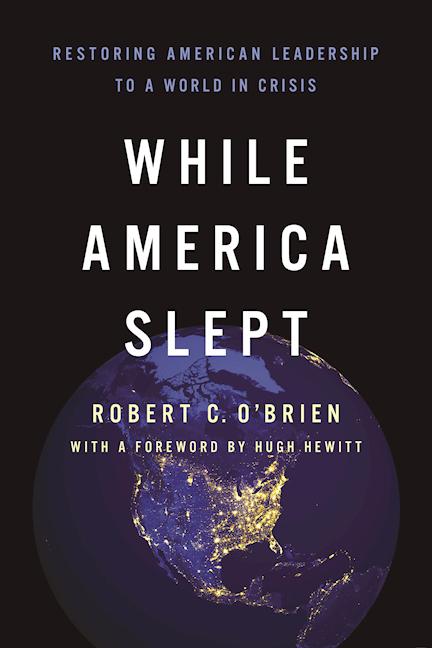
While America Slept Robert C. O'Brien's collection of essays on U.S. national security and foreign policy, with a forward by Hugh Hewitt, is a wake up call to the American people. The world has become steadily more dangerous under President Obama's "lead from behind" foreign policy. The Obama Administration's foreign policy has emboldened our adversaries and disheartened our allies. Indeed, Obama's nuclear deal with Iran is a 1938 moment. At the same time, the U.S. military has been cut and risks returning to the hollow force days of the 1970s. O'Brien lays out the challenges and provides the common sense "peace through strength" solutions that will allow the next president to make America great again. POLITICAL SCIENCE,Geopolitics
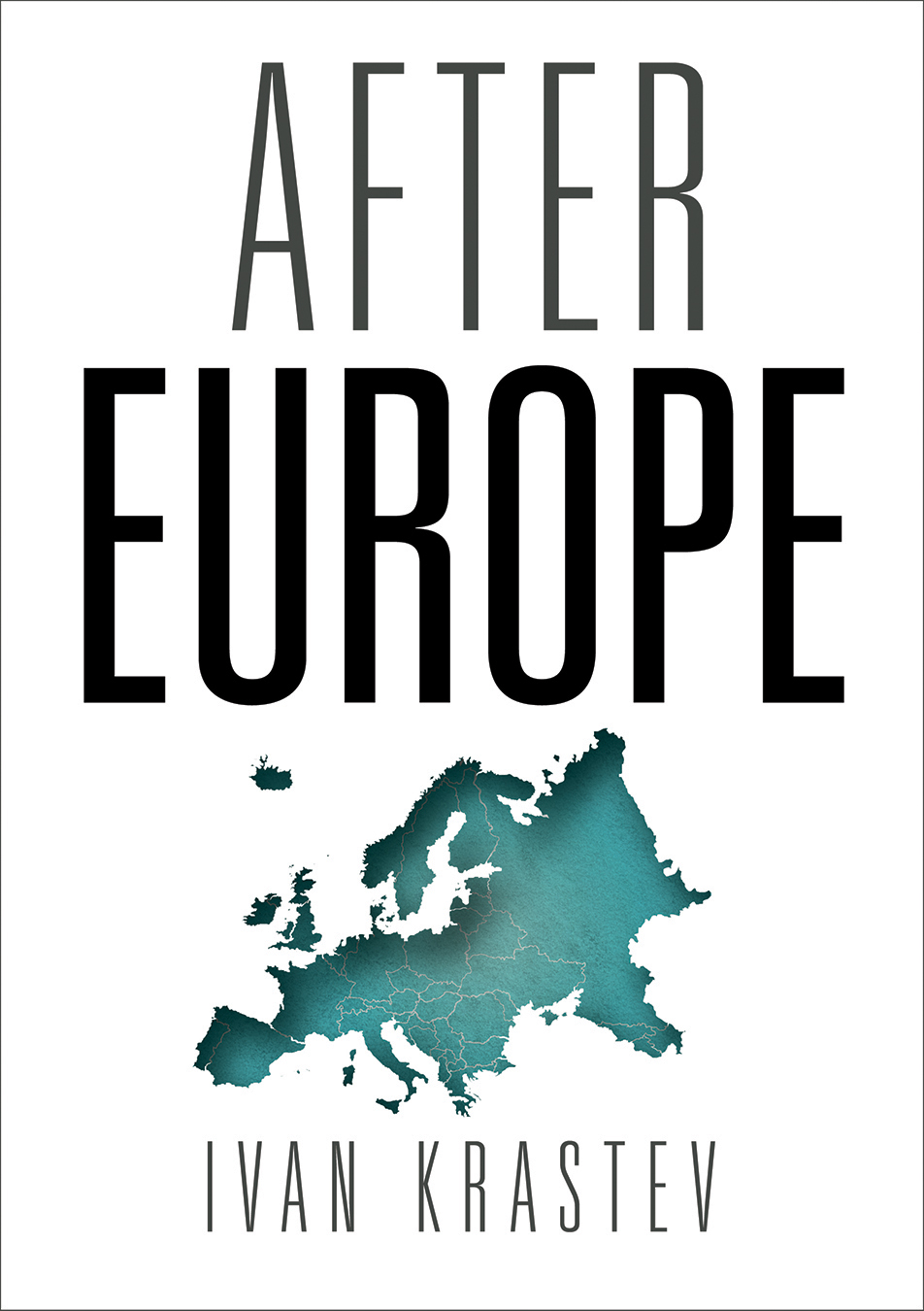
After Europe In this provocative book, renowned public intellectual Ivan Krastev reflects on the future of the European Union—and its potential lack of a future. With far-right nationalist parties on the rise across the continent and the United Kingdom planning for Brexit, the European Union is in disarray and plagued by doubts as never before. Krastev includes chapters devoted to Europe's major problems (especially the political destabilization sparked by the more than 1.3 million migrants from the Middle East, North Africa, and South Asia), the spread of right-wing populism (taking into account the election of Donald Trump in the United States), and the thorny issues facing member states on the eastern flank of the EU (including the threat posed by Vladimir Putin's Russia). He concludes by reflecting on the ominous political, economic, and geopolitical future that would await the continent if the Union itself begins to disintegrate. POLITICAL SCIENCE,Geopolitics
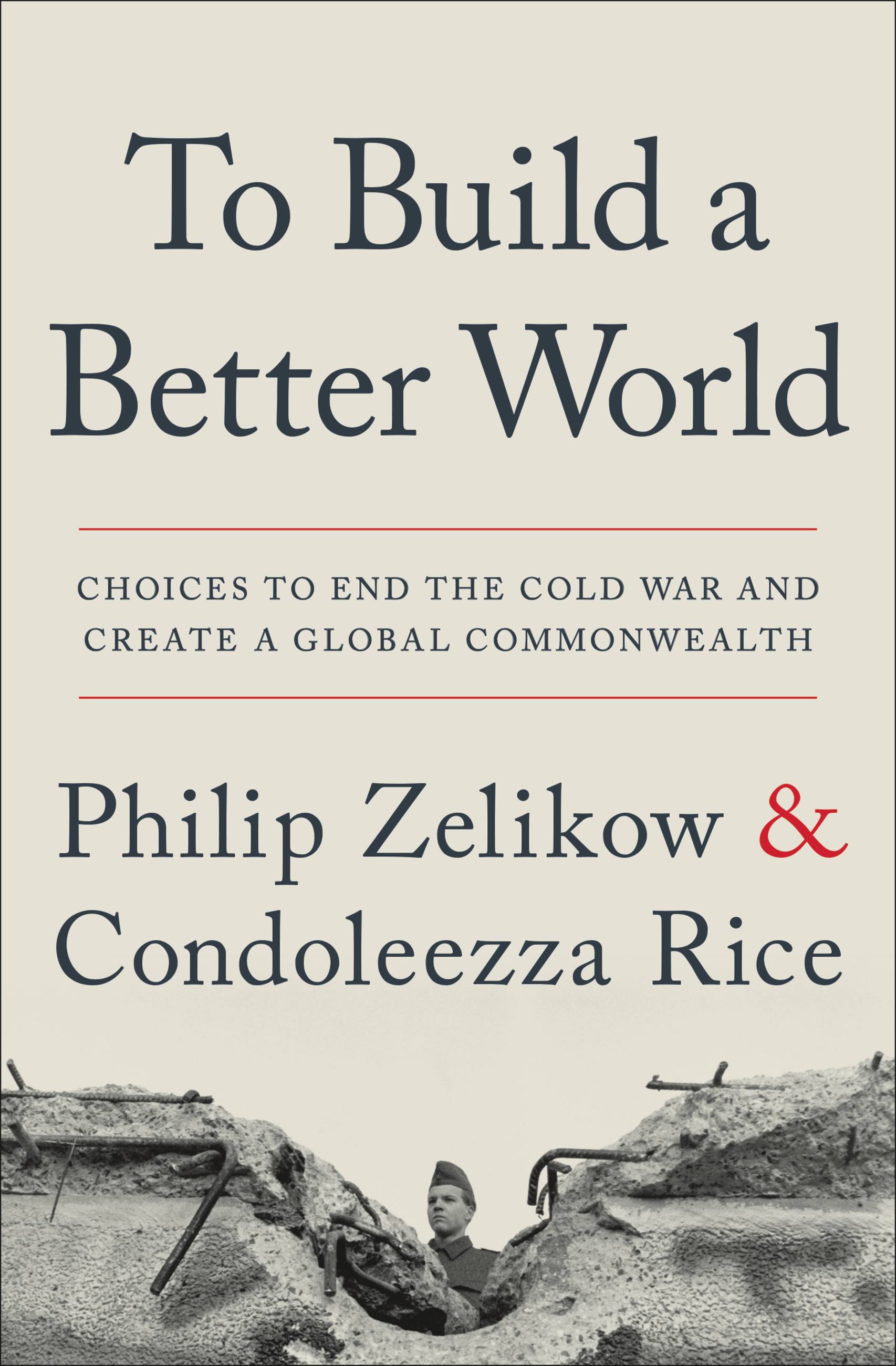
To Build a Better World A deeply researched international history and "exemplary study" (New York Times Book Review) of how a divided world ended and our present world was fashioned, as the world drifts toward another great time of choosing. Two of America's leading scholar-diplomats, Philip Zelikow and Condoleezza Rice, have combed sources in several languages, interviewed leading figures, and drawn on their own firsthand experience to bring to life the choices that molded the contemporary world. Zeroing in on the key moments of decision, the might-have-beens, and the human beings working through them, they explore both what happened and what could have happened, to show how one world ended and another took form. Beginning in the late 1970s and carrying into the present, they focus on the momentous period between 1988 and 1992, when an entire world system changed, states broke apart, and societies were transformed. Such periods have always been accompanied by terrible wars -- but not this time. This is also a story of individuals coping with uncertainty. They voice their hopes and fears. They try out desperate improvisations and careful designs. These were leaders who grew up in a "postwar" world, who tried to fashion something better, more peaceful, more prosperous, than the damaged, divided world in which they had come of age. New problems are putting their choices, and the world they made, back on the operating table. It is time to recall not only why they made their choices, but also just how great nations can step up to great challenges. Timed for the thirtieth anniversary of the fall of the Berlin Wall, To Build a Better World is an authoritative depiction of contemporary statecraft. It lets readers in on the strategies and negotiations, nerve-racking risks, last-minute decisions, and deep deliberations behind the dramas that changed the face of Europe -- and the world -- forever. p.p1 {margin: 0.0px 0.0px 0.0px 0.0px; text-align: justify; line-height: 12.1px; font: 9.0px Times} p.p2 {margin: 0.0px 0.0px 0.0px 0.0px; text-align: justify; line-height: 12.1px; font: 9.0px Times; min-height: 11.0px} p.p3 {margin: 0.0px 0.0px 0.0px 0.0px; text-align: justify; line-height: 9.1px; font: 9.0px Times; min-height: 11.0px} p.p4 {margin: 0.0px 0.0px 0.0px 0.0px; text-align: justify; line-height: 9.1px; font: 9.0px Times} POLITICAL SCIENCE,Geopolitics
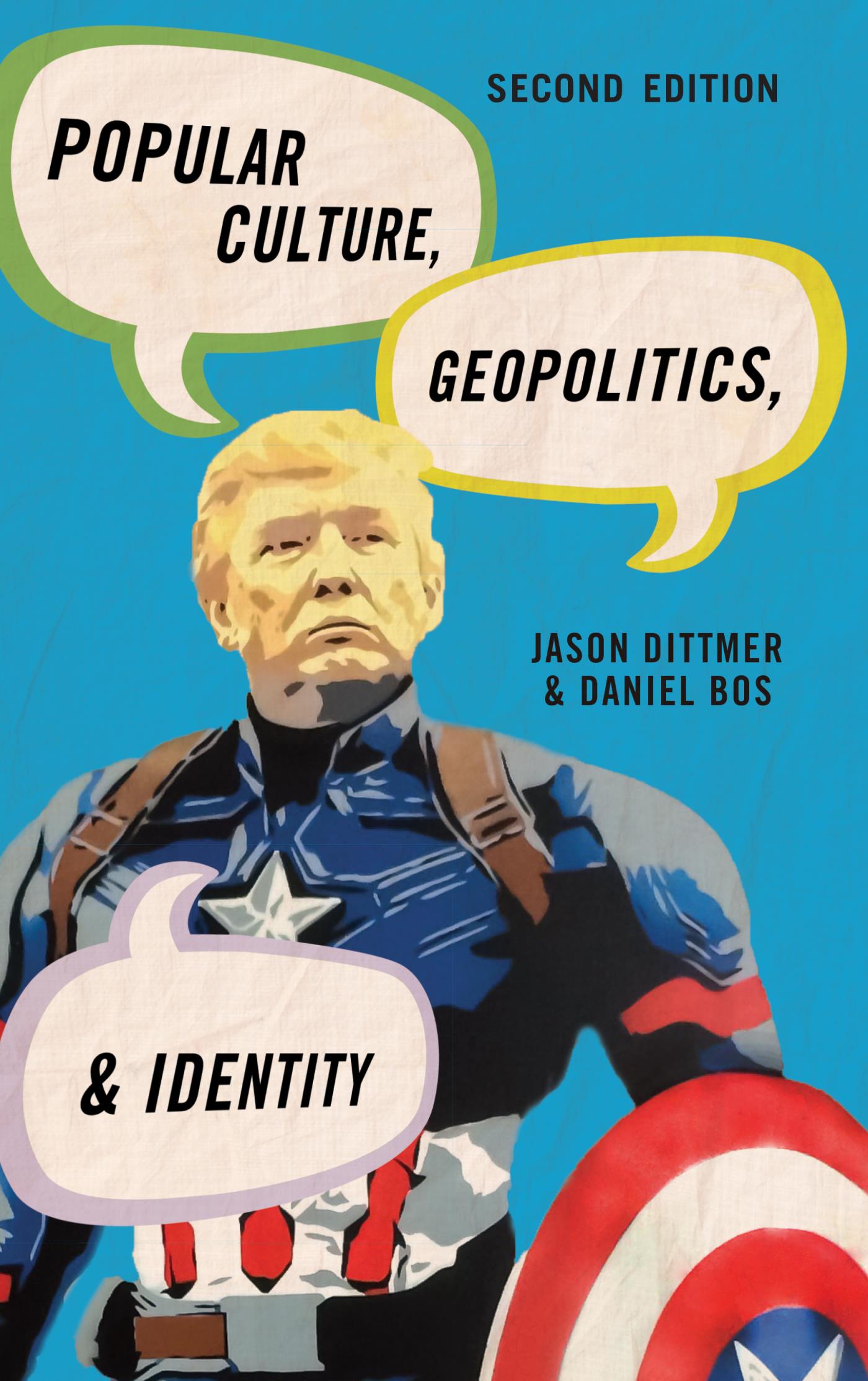
Popular Culture, Geopolitics, and Identity Now in a thoroughly revised edition, this innovative textbook surveys the field of popular geopolitics, exploring the relationship between popular culture and international relations from a geographical perspective. Using colorful current examples, it brings together a diverse, multidisciplinary literature and makes it understandable and relevant. POLITICAL SCIENCE,Geopolitics

Tectonic Politics Political risk now affects more markets and countries than ever before and that risk will continue to rise. But traditional methods of managing political risk are no longer legitimate or effective. In Tectonic Politics, Nigel Gould-Davies explores the complex, shifting landscape of political risk and how to navigate it. He analyses trends in each form of political risk: the power to destroy, seize, regulate, and tax. He shows how each of these forms reflects a deeper transformation of the global political economy that is reordering the relationship between power, wealth, and values. In a world where everything is political, the craft of engagement is as important as the science of production and the art of the deal. The successful company must integrate that craftthe engager’s way of seeing and doinginto strategy and culture. Drawing on a career in academia, business, and diplomacy, Gould-Davies provides corporate leaders, scholars, and engaged citizens with a groundbreaking study of the fastest-rising political risk today. As tectonic plates shape the earth, he writes, so tectonic politics forges its governance. POLITICAL SCIENCE,Geopolitics

Blowout #1 NEW YORK TIMES BESTSELLER • Big Oil and Gas Versus Democracy—Winner Take All “A rollickingly well-written book, filled with fascinating, exciting, and alarming stories about the impact of the oil and gas industry on the world today.”—The New York Times Book Review In 2010, the words “earthquake swarm” entered the lexicon in Oklahoma. That same year, a trove of Michael Jackson memorabilia—including his iconic crystal-encrusted white glove—was sold at auction for over $1 million to a guy who was, officially, just the lowly forestry minister of the tiny nation of Equatorial Guinea. And in 2014, Ukrainian revolutionaries raided the palace of their ousted president and found a zoo of peacocks, gilded toilets, and a floating restaurant modeled after a Spanish galleon. Unlikely as it might seem, there is a thread connecting these events, and Rachel Maddow follows it to its crooked source: the unimaginably lucrative and equally corrupting oil and gas industry. With her trademark black humor, Maddow takes us on a switchback journey around the globe, revealing the greed and incompetence of Big Oil and Gas along the way, and drawing a surprising conclusion about why the Russian government hacked the 2016 U.S. election. She deftly shows how Russia’s rich reserves of crude have, paradoxically, stunted its growth, forcing Putin to maintain his power by spreading Russia’s rot into its rivals, its neighbors, the West’s most important alliances, and the United States. Chevron, BP, and a host of other industry players get their star turn, most notably ExxonMobil and the deceptively well-behaved Rex Tillerson. The oil and gas industry has weakened democracies in developed and developing countries, fouled oceans and rivers, and propped up authoritarian thieves and killers. But being outraged at it is, according to Maddow, “like being indignant when a lion takes down and eats a gazelle. You can’t really blame the lion. It’s in her nature.” Blowout is a call to contain the lion: to stop subsidizing the wealthiest businesses on earth, to fight for transparency, and to check the influence of the world’s most destructive industry and its enablers. The stakes have never been higher. As Maddow writes, “Democracy either wins this one or disappears.” POLITICAL SCIENCE,Geopolitics
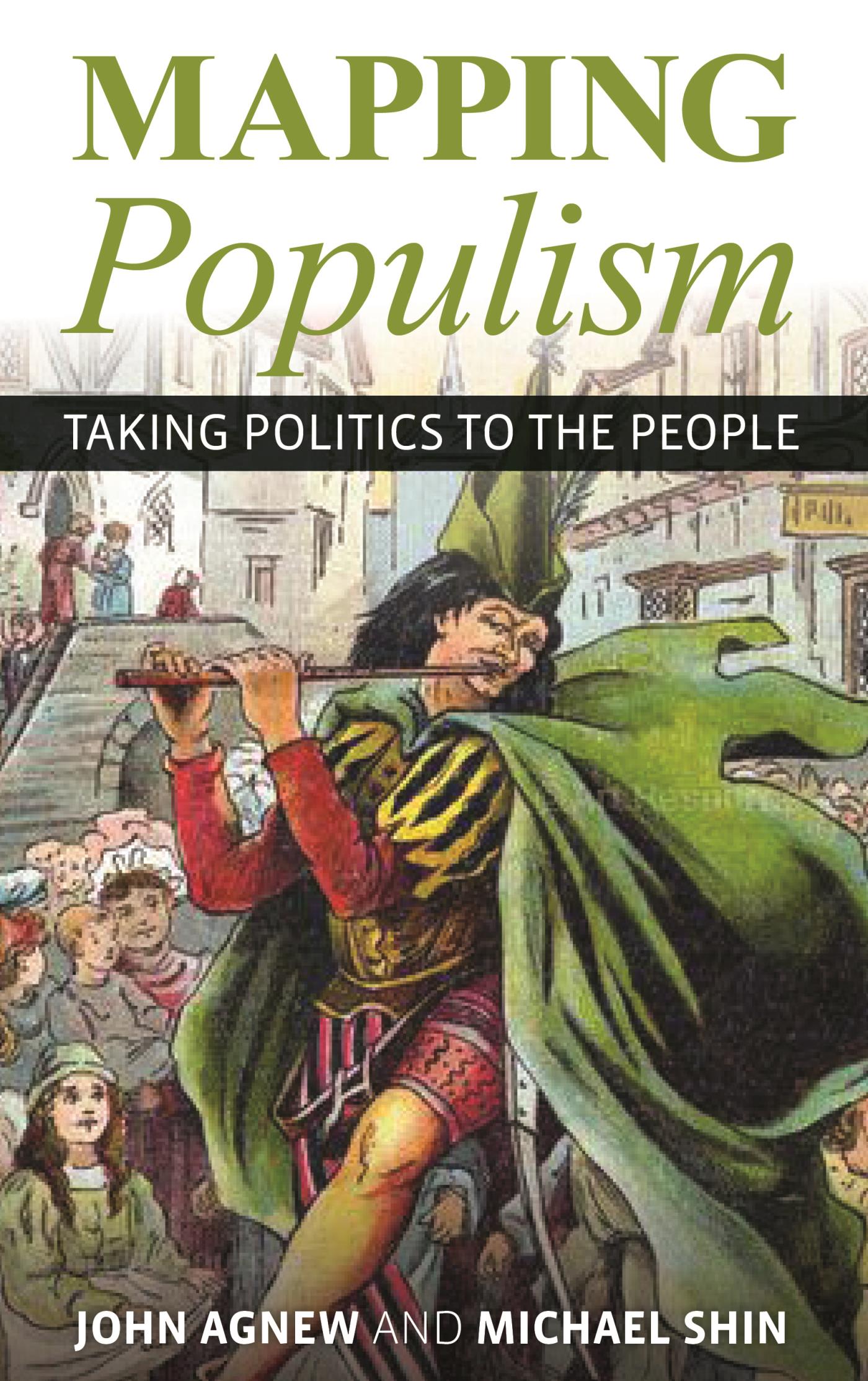
Mapping Populism This concise book explores the rise of populism, comparing the electoral success of populist movements and politicians in Europe and the United States. Organized around themes of turnout, leadership, and media, and illustrated with compelling maps, Mapping Populism encourages discussion on an increasingly important topic—and on the future of democracy itself. POLITICAL SCIENCE,Geopolitics

The Dissent Channel A young diplomat's account of her assignment in South Sudan, a firsthand example of US foreign policy that has failed in its diplomacy and accountability around the world. In 2017, Elizabeth Shackelford wrote a pointed resignation letter to her then boss, Secretary of State Rex Tillerson. She had watched as the State Department was gutted, and now she urged him to stem the bleeding by showing leadership and commitment to his diplomats and the country. If he couldn't do that, she said, "I humbly recommend that you follow me out the door." With that, she sat down to write her story and share an urgent message. In The Dissent Channel, former diplomat Elizabeth Shackelford shows that this is not a new problem. Her experience in 2013 during the precarious rise and devastating fall of the world's newest country, South Sudan, exposes a foreign policy driven more by inertia than principles, to suit short-term political needs over long-term strategies. Through her story, Shackelford makes policy and politics come alive. And in navigating both American bureaucracy and the fraught history and present of South Sudan, she conveys an urgent message about the devolving state of US foreign policy. POLITICAL SCIENCE,Geopolitics

After Europe A impassioned defense of the European Union and a concise analysis of its present challenges and future In this provocative book, renowned public intellectual Ivan Krastev reflects on the future of the European Union—and its potential lack of a future. With far-right nationalist parties on the rise across the continent and the United Kingdom planning for Brexit, the European Union is in disarray and plagued by doubts as never before. Krastev includes chapters devoted to Europe's major problems (especially the political destabilization sparked by the more than 1.3 million migrants from the Middle East, North Africa, and South Asia), the spread of right-wing populism (taking into account the election of Donald Trump in the United States), and the thorny issues facing member states on the eastern flank of the EU (including the threat posed by Vladimir Putin's Russia). In a new afterword written in the wake of the 2019 EU parliamentary elections, Krastev concludes that although the union is as fragile as ever, its chances of enduring are much better than they were just a few years ago. POLITICAL SCIENCE,Geopolitics
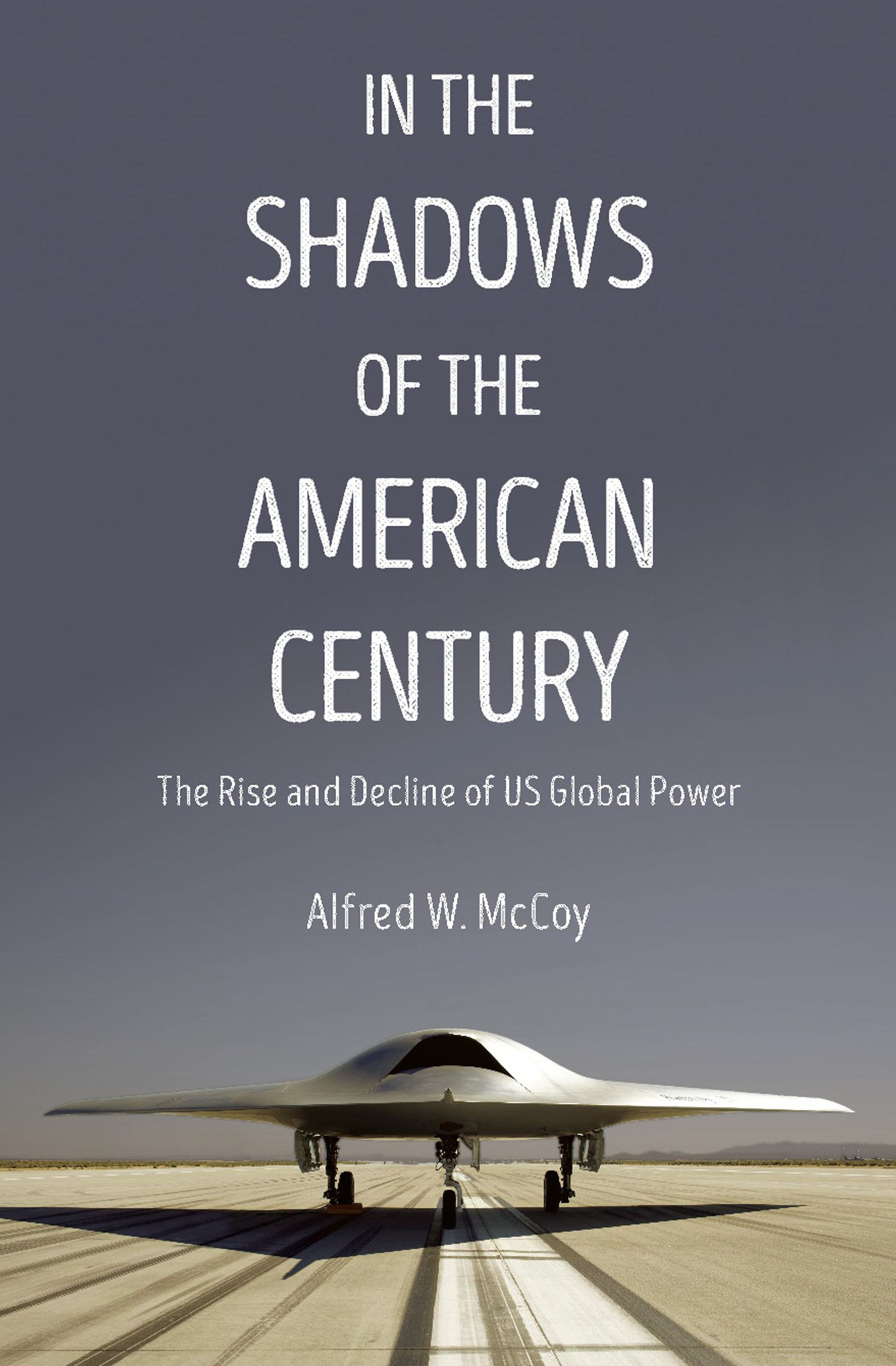
In the Shadows of the American Century The award-winning historian delivers a “brilliant and deeply informed†analysis of American power from the Spanish-American War to the Trump Administration (New York Journal of Books). In this sweeping and incisive history of US foreign relations, historian Alfred McCoy explores America’s rise as a world power from the 1890s through the Cold War, and its bid to extend its hegemony deep into the twenty-first century. Since American dominance reached its apex at the close of the Cold War, the nation has met new challenges that it is increasingly unequipped to handle. From the disastrous invasion of Iraq to the failure of the Trans-Pacific Partnership, fracturing military alliances, and the blundering nationalism of Donald Trump, McCoy traces US decline in the face of rising powers such as China. He also offers a critique of America’s attempt to maintain its position through cyberwar, covert intervention, client elites, psychological torture, and worldwide surveillance. POLITICAL SCIENCE,Geopolitics
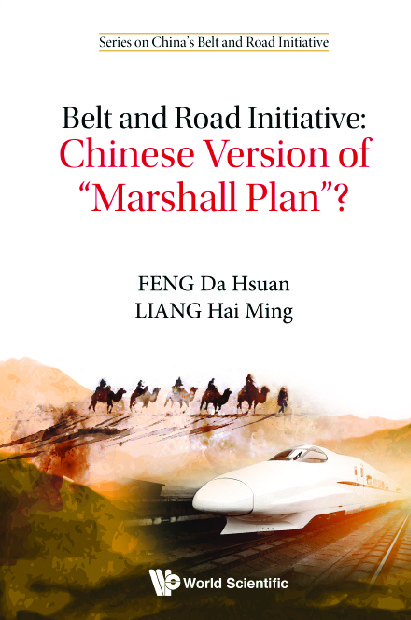
Belt And Road Initiative This book views the Belt and Road Initiative (BRI), a bold and all-encompassing 21st century global effort by China, with unprecedented perspectives. The BRI could be summarised as a 'revitalization' of China's ancient land-based and maritime silk roads, but it should be noted that its impact on China and the world stands on the foundation of omnipresent economics and how China transforms its mindset in the 21st century.Though initiated by China, the BRI's implementation has been a many-to-many effort from the start. This multi-regional and multi-national effort is distinctly different from the one-to-many effort of the Marshall Plan. The two meaning-defining chapters of this book, 'Omnipresent Economics: The Belt and Road Initiative Underpinning' and 'Supercontinent, Neo-Renaissance and Cultural Communications: The Millennium Mindset Transformations Induced by the Belt and Road Initiative', have made it abundantly clear that the BRI discussions presented are unique.The discussions of this book could shed new light on the BRI, a long-term and profound initiative by China, which in today's global discussions and debates, are entirely confined to geopolitical and economics arenas. POLITICAL SCIENCE,Geopolitics

China's Rise In Mainland Asean The rationale for this volume on China's Rise in Mainland ASEAN: New Dynamics and Changing Landscapes stems from the rise in recent years of China, ASEAN's giant neighbor, and in its wake the significant economic, political, and socio-cultural developments in the ASEAN region. In the last two decades, China has successfully established itself as a powerful regional and global power, surpassing Japan in 2010 as the second largest economy of the world, and has become a major player in the affairs of South East Asian nations.At the same time, while China's spectacular growth makes it vulnerable in terms of expanding its global dependence, it also makes its neighbours equally vulnerable due to their growing dependence on China. All of these developments have led China through its evolving foreign policy to exert considerable influence on its immediate ASEAN neighbours in many complex ways.While the China-ASEAN bilateral relations are soaring, there are growing concerns among ASEAN member countries about the nature of China's engagement with ASEAN. In this context, this book focuses on China's influence on mainland ASEAN countries: Cambodia, Lao PDR, Myanmar, Thailand and Vietnam. China's Rise in Mainland ASEAN: New Dynamics and Changing Landscapes contributes useful insights, rich discussions, as well as the debates relevant to building a knowledge base about and better understanding of China's rising influence in mainland ASEAN. POLITICAL SCIENCE,Geopolitics
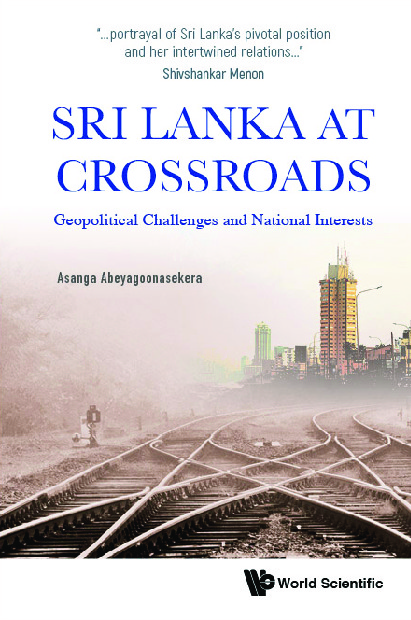
Sri Lanka At Crossroads Having celebrated its 70th year of independence in 2018, Sri Lanka, a strategically-positioned island nation, now finds itself with the potential to be a super connector in fast-developing Asia. While carving out a place for itself in the international arena, Sri Lanka has simultaneously had to look inwards to recover and rebuild its potential, bruised by an era of colonial rule and nearly 30 years of a civil war, with two youth insurrections.This book examines these twin dimensions. First, how Sri Lanka is negotiating its international reach and the spheres of influence that extend from other Asian and world powers, and second, how the country is engaging in nation-building, from days of racial riots to ones of peace-building, reconciliation, more robust governance, and the development of cyber security.Written from the perspective of a Sri Lankan academic and the head of the national security think tank, this book offers insights into how the country has addressed its post-conflict as well as geopolitical challenges, navigated through domestic politics, and ramped up peace-building efforts, to now reach a junction where it can put its foot firmly on the road to prosperity in a new Asian world order. POLITICAL SCIENCE,Geopolitics

The China Challenge “A standout . . . a balanced, informative, and highly intelligent guide to dealing with China.â€â€”Fareed Zakaria Many see China as a rival superpower to the United States and imagine the country’s rise to be a threat to U.S. leadership in Asia and beyond. Thomas J. Christensen argues against this zero-sum vision. Instead, he describes a new paradigm in which the real challenge lies in dissuading China from regional aggression while encouraging the country to contribute to the global order. Drawing on decades of scholarship and experience as a senior diplomat, Christensen offers a compelling new assessment of U.S.-China relations that is essential reading for anyone interested in the future of the globalized world. The China Challenge shows why China is nowhere near powerful enough to be considered a global “peer competitor†of the United States, but it is already strong enough to destabilize East Asia and to influence economic and political affairs worldwide. Despite China’s impressive achievements, the Chinese Communist Party faces enormous challenges. Christensen shows how nationalism and the threat of domestic instability influence the party’s decisions on issues like maritime sovereignty disputes, global financial management, control of the Internet, climate change, and policies toward Taiwan and Hong Kong. China benefits enormously from the current global order and has no intention of overthrowing it; but that is not enough. China’s active cooperation is essential to global governance. Never before has a developing country like China been asked to contribute so much to ensure international stability. If China obstructs international efforts to confront nuclear proliferation, civil conflicts, financial instability, and climate change, those efforts will falter, but even if China merely declines to support such efforts, the problems will grow vastly more complicated. Analyzing U.S.-China policy since the end of the Cold War, Christensen articulates a balanced strategic approach that explains why we should aim not to block China’s rise but rather to help shape its choices so as to deter regional aggression and encourage China’s active participation in international initiatives that benefit both nations. POLITICAL SCIENCE,Geopolitics

Imagined Geographies in the Indo-Tibetan Borderlands This book is an ethnography of culture and politics in Monyul, a Tibetan Buddhist cultural region in west Arunachal Pradesh, Northeast India. For nearly three centuries, Monyul was part of the Tibetan state, and the Monpas, as the communities inhabiting this region are collectively known, participated in trans-Himalayan trade and pilgrimage. Following the colonial demarcation of the Indo-Tibetan boundary in 1914, the fall of the Tibetan state in 1951, and the India-China boundary war in 1962, Monyul was gradually integrated into India and the Monpas became one of the Scheduled Tribes of India. In 2003, the Monpas began a demand for autonomy, under the leadership of Tsona Gontse Rinpoche. This book examines the narratives and politics of the autonomy movement regarding language, place-names, and trans-border kinship, against the backdrop of the India-China border dispute. It explores how the Monpas negotiate multiple identities to imagine new forms of community that transcend regional and national borders. POLITICAL SCIENCE,Geopolitics

The Global Politics of Sport Sport presents one of the most advanced cases of 'globalisation,' arguably because there are fewer cultural and political obstacles to the development of trade and international power in sport than there are in other fields. Thus there has been a change in the nature of the politics of sport since the end of the Cold War; the subject must be rewritten to acknowledge a twenty-first century world in which international sporting organisations and transnational corporations have become far more important than states.The Global Politics of Sport presents a range of essays examining the emerging global political issues in twenty-first century sport including: · The role, and power of organisations such as FIFA and the IOC· The influence of US exceptionalism · The construction of global sports heroes· Tensions developing within traditionally 'alternative' sports in a global commercial cultureThe Global Politics of Sport presents new and fresh exploration of different conceptions of sport as a purely commercial activity and as an activity as embodying 'higher' social and ethical values. POLITICAL SCIENCE,Globalization
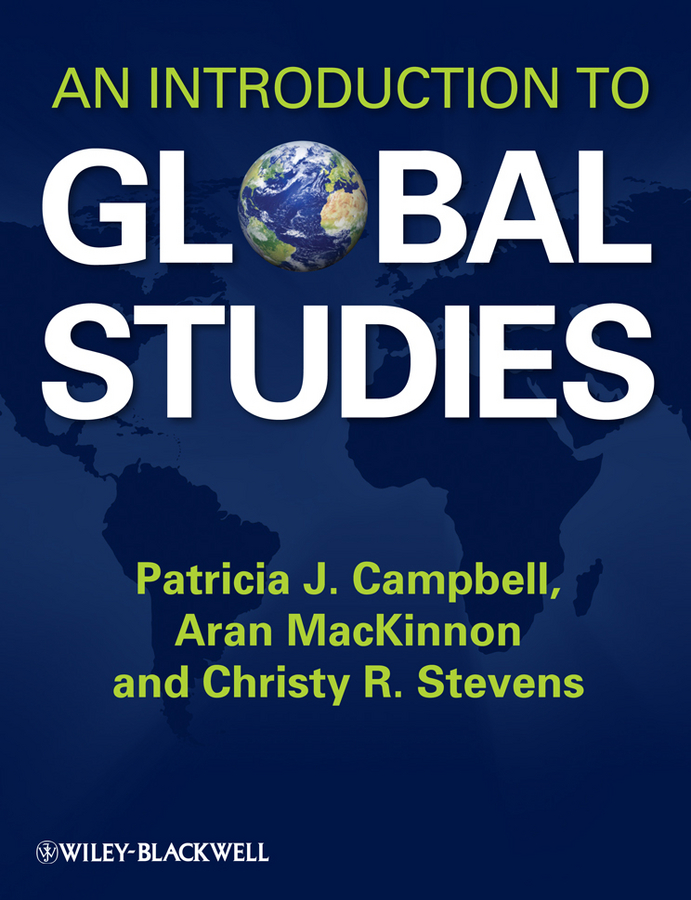
An Introduction to Global Studies Taking an interdisciplinary approach, An Introduction to Global Studies presents readers with a solid introduction to the complex, interconnected forces and issues confronting today's globalized world. Introduces readers to major theories, key terms, concepts, and notable theorists Equips readers with the basic knowledge and conceptual tools necessary for thinking critically about the complex issues facing the global community Includes a variety of supplemental features to facilitate learning and enhance readers' understanding of the material POLITICAL SCIENCE,Globalization

Hegemony or Survival From the world's foremost intellectual activist, an irrefutable analysis of America's pursuit of total domination and the catastrophic consequences that are sure to follow The United States is in the process of staking out not just the globe but the last unarmed spot in our neighborhood-the heavens-as a militarized sphere of influence. Our earth and its skies are, for the Bush administration, the final frontiers of imperial control. In Hegemony or Survival , Noam Chomsky investigates how we came to this moment, what kind of peril we find ourselves in, and why our rulers are willing to jeopardize the future of our species. With the striking logic that is his trademark, Chomsky dissects America's quest for global supremacy, tracking the U.S. government's aggressive pursuit of policies intended to achieve "full spectrum dominance" at any cost. He lays out vividly how the various strands of policy-the militarization of space, the ballistic-missile defense program, unilateralism, the dismantling of international agreements, and the response to the Iraqi crisis-cohere in a drive for hegemony that ultimately threatens our survival. In our era, he argues, empire is a recipe for an earthly wasteland. Lucid, rigorous, and thoroughly documented, Hegemony or Survival promises to be Chomsky's most urgent and sweeping work in years, certain to spark widespread debate. POLITICAL SCIENCE,Globalization
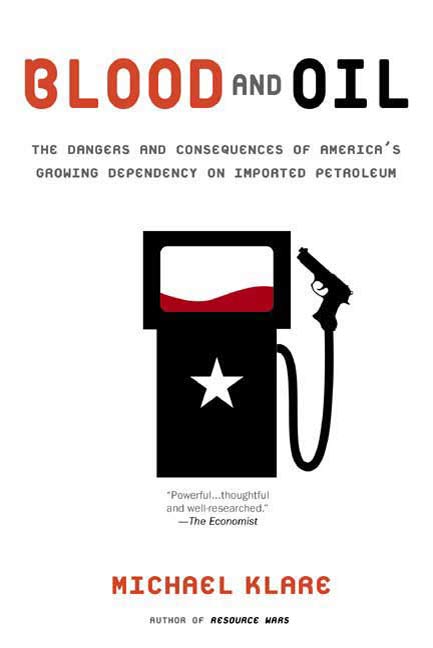
Blood and Oil From the author of Resource Wars, a landmark assessment of the critical role of petroleum in America's actions abroad In his pathbreaking Resource Wars, world security expert Michael T. Klare alerted us to the role of resources in conflicts in the post-Cold War world. Now, in Blood and Oil, he concentrates on a single precious commodity, petroleum, while issuing a warning to the United States-its most powerful, and most dependent, global consumer. Since September 11th and the commencement of the "war on terror," the world's attention has been focused on the relationship between U.S. foreign policy in the Middle East and the oceans of crude oil that lie beneath the region's soil. Klare traces oil's impact on international affairs since World War II, revealing its influence on the Truman, Eisenhower, Nixon, and Carter doctrines. He shows how America's own wells are drying up as our demand increases; by 2010, the United States will need to import 60 percent of its oil. And since most of this supply will have to come from chronically unstable, often violently anti-American zones-the Persian Gulf, the Caspian Sea, Latin America, and Africa-our dependency is bound to lead to recurrent military involvement. With clarity and urgency, Blood and Oil delineates the United States' predicament and cautions that it is time to change our energy policies, before we spend the next decades paying for oil with blood. POLITICAL SCIENCE,Globalization
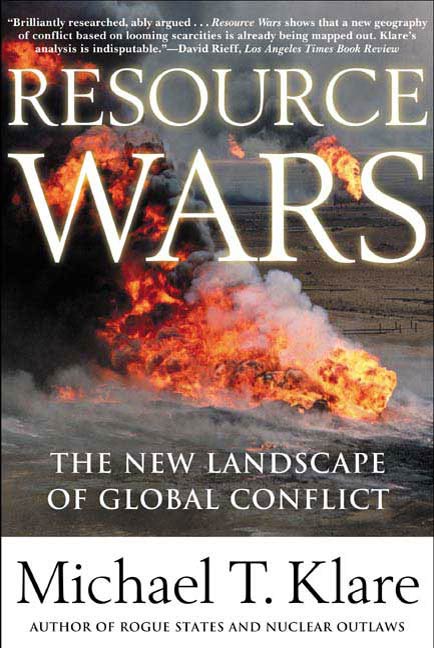
Resource Wars This sobering look at the future of warfare predicts that conflicts will now be fought over diminishing supplies of our most precious natural resources. From the barren oilfields of Central Asia to the lush Nile delta, from the busy shipping lanes of the South China Sea to the uranium mines and diamond fields of sub-Saharan Africa, Resource Wars looks at the growing impact of resource scarcity on the military policies of nations. International security expert Michael T. Klare argues that in the early decades of the new millennium wars will be fought not over ideology but over resources, as states battle to control dwindling supplies of precious natural commodities. The political divisions of the Cold War, Klare asserts, are giving way to an immense global scramble for essential materials, such as oil, timber, minerals, and water. And as armies throughout the world define resource security as their primary mission, widespread instability is bound to follow, especially in those places where resource competition overlaps with long-standing disputes over territorial rights. A much-needed assessment of a changed world, Resource Wars is a compelling look at the future of warfare in an era of heightened environmental stress and accelerated economic competition. POLITICAL SCIENCE,Globalization
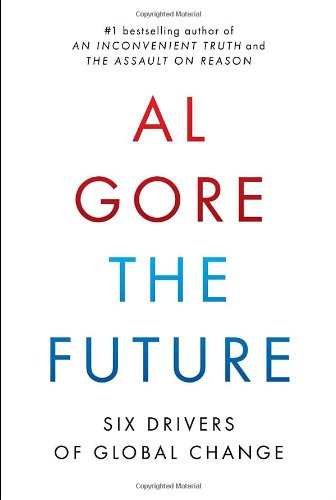
The Future NEW YORK TIMES BESTSELLER From the former vice president and #1 New York Times bestselling author comes An Inconvenient Truth for everything—a frank and clear-eyed assessment of six critical drivers of global change in the decades to come. Ours is a time of revolutionary change that has no precedent in history. With the same passion he brought to the challenge of climate change, and with his decades of experience on the front lines of global policy, Al Gore surveys our planet’s beclouded horizon and offers a sober, learned, and ultimately hopeful forecast in the visionary tradition of Alvin Toffler’s Future Shock and John Naisbitt’s Megatrends. In The Future, Gore identifies the emerging forces that are reshaping our world: • Ever-increasing economic globalization has led to the emergence of what he labels “Earth Inc.”—an integrated holistic entity with a new and different relationship to capital, labor, consumer markets, and national governments than in the past. • The worldwide digital communications, Internet, and computer revolutions have led to the emergence of “the Global Mind,” which links the thoughts and feelings of billions of people and connects intelligent machines, robots, ubiquitous sensors, and databases. • The balance of global political, economic, and military power is shifting more profoundly than at any time in the last five hundred years—from a U.S.-centered system to one with multiple emerging centers of power, from nation-states to private actors, and from political systems to markets. • A deeply flawed economic compass is leading us to unsustainable growth in consumption, pollution flows, and depletion of the planet’s strategic resources of topsoil, freshwater, and living species. • Genomic, biotechnology, neuroscience, and life sciences revolutions are radically transforming the fields of medicine, agriculture, and molecular science—and are putting control of evolution in human hands. • There has been a radical disruption of the relationship between human beings and the earth’s ecosystems, along with the beginning of a revolutionary transformation of energy systems, agriculture, transportation, and construction worldwide. From his earliest days in public life, Al Gore has been warning us of the promise and peril of emergent truths—no matter how “inconvenient” they may seem to be. As absorbing as it is visionary, The Future is a map of the world to come, from a man who has looked ahead before and been proven all too right. Praise for The Future “Magisterial . . . The passion is unmistakable. So is the knowledge. Practically every page offers an illumination.”—Bloomberg “In The Future . . . Gore takes on a subject whose scale matches that of his achievements and ambition.”—The New York Times Book Review “Historically grounded . . . Gore’s strengths lie in his passion for the subject and in his ability to take the long view by putting current events and trends in historical context.”—Publishers Weekly “Provocative, smart, densely argued . . . a tour de force of Big Picture thinking.”—Kirkus Reviews (starred review) “A luminously intelligent analysis that is packed with arresting ideas and facts.”—The Guardian POLITICAL SCIENCE,Globalization

Justice Globalism This is a stimulating and insightful analysis of the role of global justice organizations, written by some of the biggest names in the field of globalisation studies POLITICAL SCIENCE,Globalization
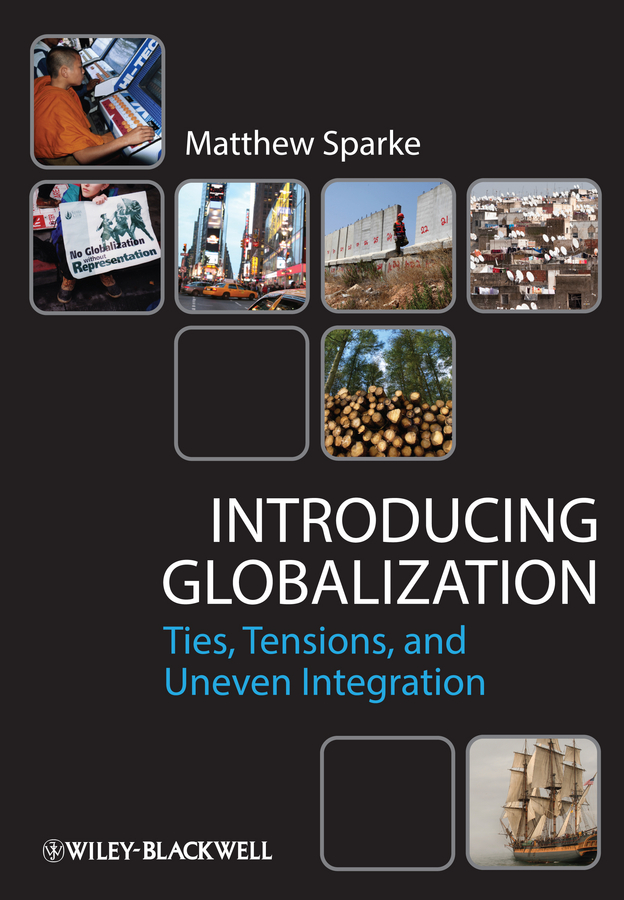
Introducing Globalization Designed specifically for introductory globalization courses, Introducing Globalization helps students to develop informed opinions about globalization, inviting them to become participants rather than just passive learners. Identifies and explores the major economic, political and social ties that comprise contemporary global interdependency Examines a broad sweep of topics, from the rise of transnational corporations and global commodity chains, to global health challenges and policies, to issues of worker solidarity and global labor markets, through to emerging forms of global mobility by both business elites and their critics Written by an award-winning teacher, and enhanced throughout by numerous empirical examples, maps, tables, an extended bibliography, glossary of key terms, and suggestions for further reading and student research Supported by additional web resources – available upon publication at www.wiley.com/go/sparke – including hot links to news reports, examples of globalization and other illustrative sites, and archived examples of student projects Engage with fellow readers of Introducing Globalization on the book's Facebook page at www.facebook.com/IntroducingGlobalization, or learn more about this topic by enrolling in the free Coursera course Globalization and You at www.coursera.org/course/globalization POLITICAL SCIENCE,Globalization
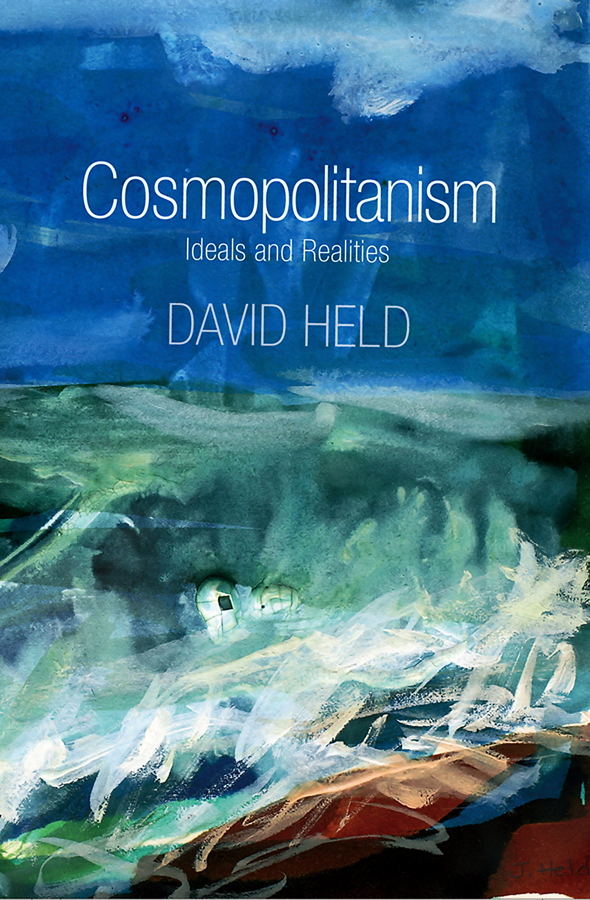
Cosmopolitanism This book sets out the case for a cosmopolitan approach to contemporary global politics. It presents a systematic theory of cosmopolitanism, explicating its core principles and justifications, and examines the role many of these principles have played in the development of global politics, such as framing the human rights regime. The framework is then used to address some of the most pressing issues of our time: the crisis of financial markets, climate change and the fallout from the wars in Afghanistan and Iraq. In each case, Held argues that realistic politics is exhausted, and that cosmopolitanism is the new realism. See also Garrett Wallace Brown and David Held's The Cosmopolitanism Reader . POLITICAL SCIENCE,Globalization

The Historical Muhammad In his quest for the historical Muhammad, Zeitlin's chief aim is to catch glimpses of the birth of Islam and the role played by its extraordinary founder. Islam, as its Prophet came to conceive it, was a strict and absolute monotheism. How Muhammad had arrived at this view is not a problem for Muslims, who believe that the Prophet received a revelation from Allah or God, mediated by the Angel Gabriel. For scholars, however, interested in placing Muhammad in the historical context of the seventh-century Arabian Peninsula, the source of the Prophets inspiration is a significant question. It is apparent that the two earlier monotheisms, Judaism and Christianity, constituted an influential presence in the Hijaz, the region comprising Mecca and Medina. Indeed, Jewish communities were salient here, especially in Medina and other not-too-distant oases. Moreover, in addition to the presence of Jews and Christians, there existed a third category of individuals, the Hanifs, who, dissatisfied with their polytheistic beliefs, had developed monotheistic ideas. Zeitlin assesses the extent to which these various influences shaped the emergence of Islam and the development of the Prophets beliefs. He also seeks to understand how the process set in motion by Muhammad led, not long after his death, to the establishment of a world empire. POLITICAL SCIENCE,Globalization
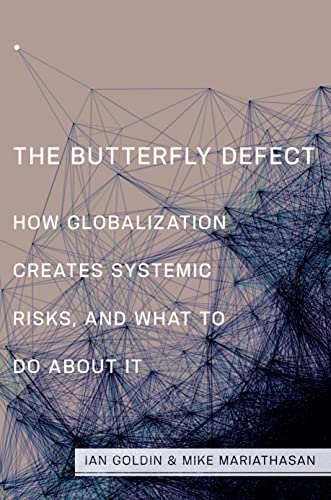
The Butterfly Defect How to better manage systemic risks—from cyber attacks and pandemics to financial crises and climate change—in a globalized world The Butterfly Defect addresses the widening gap between the new systemic risks generated by globalization and their effective management. It shows how the dynamics of turbo-charged globalization has the potential and power to destabilize our societies. Drawing on the latest insights from a wide variety of disciplines, Ian Goldin and Mike Mariathasan provide practical guidance for how governments, businesses, and individuals can better manage globalization and risk. Goldin and Mariathasan demonstrate that systemic risk issues are now endemic everywhere—in supply chains, pandemics, infrastructure, ecology and climate change, economics, and politics. Unless we address these concerns, they will lead to greater protectionism, xenophobia, nationalism, and, inevitably, deglobalization, rising inequality, conflict, and slower growth. The Butterfly Defect shows that mitigating uncertainty and risk in an interconnected world is an essential task for our future. POLITICAL SCIENCE,Globalization

Social Sciences The social sciences are about people and the relationships between individuals and the social and material world we live in. They are about the social structures which shape – and are shaped by – social forces such as ethnicity, race, gender, sexuality and age and the bodies we inhabit. How are these relationships changing and to what extent and how can people influence change? What are the big issues which concern us today? How can the social sciences help us to understand what is going on? Social Sciences: The Big Issues third edition looks at what matters in terms of what is changing and what remains the same in contemporary life, bringing together personal concerns and social forces. Fully revised and updated, this book explores some of the debates about how we live our personal, domestic and emotional lives at a time of change and disruption, including economic crises and uncertainties. The issues covered include: changing selves and personal lives; the role of consumption and consumerism; materialism and material culture; as well as citizenship, migration and globalization as both opportunities and sources of inequality in the contemporary world and in everyday lives. The third edition of Social Sciences: The Big Issues provides a clear, accessible introduction to the ideas and approaches of the social sciences across a range of disciplines, including sociology, psychology and politics. POLITICAL SCIENCE,Globalization

The Globalization Reader Completely revised and updated, the fifth edition of this well-regarded textbook charts key topics and recent research in globalization along with the latest complexities and controversies in the field. Includes a new section on globalization and identity and new readings on global inequality, mental illness, structural violence, microfinance, blood diamonds, world citizenship, the global justice movement, and sumo wrestling Contains essential, thought-provoking readings by prominent scholars, activists, and organizations on the many dimensions of globalization, from political and economic issues to cultural and experiential ones Examines foundational topics, such as the experience of globalization, economic and political globalization, the role of media and religion in cultural globalization, women’s rights, environmentalism, global civil society, and the alternative globalization movement Retains the helpful student features from prior editions, including an accessible format, concise introductions to major topics, stimulating examples, and discussion questions for each selection and section POLITICAL SCIENCE,Globalization
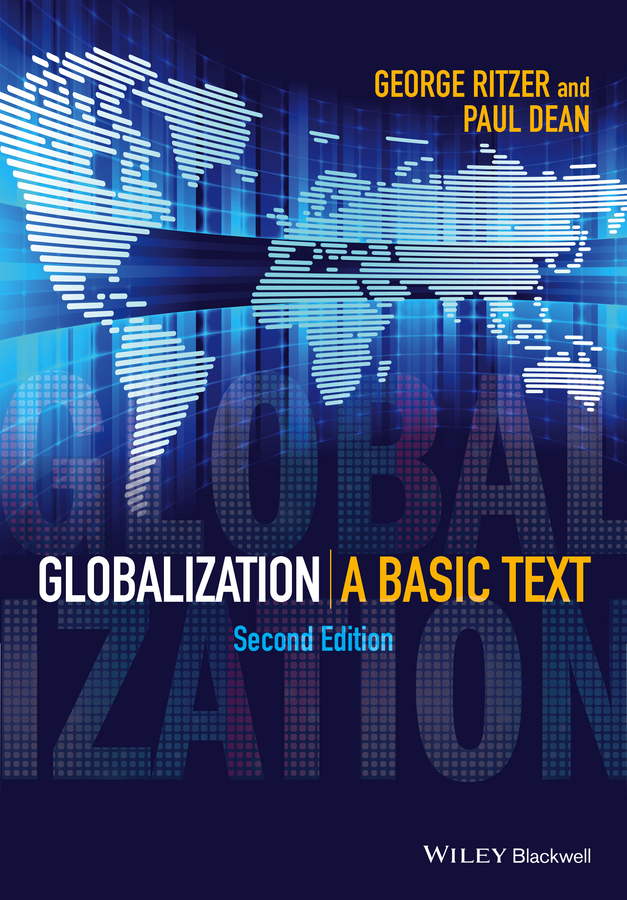
Globalization Updated to reflect recent global developments, the second edition of Globalization: A Basic Text presents an up-to-date introduction to major trends and topics relating to globalization studies. Features updates and revisions in its accessible introduction to key theories and major topics in globalization Includes an enhanced emphasis on issues relating to global governance, emerging technology, global flows of people, human trafficking, global justice movements, and global environmental sustainability Utilizes a unique set of metaphors to introduce and explain the highly complex nature of globalization in an engaging and understandable manner Offers an interdisciplinary approach to globalization by drawing from fields that include sociology, global political economy, political science, international relations, geography, and anthropology Written by an internationally recognized and experienced author team POLITICAL SCIENCE,Globalization

Earth Democracy World-renowned environmental activist and physicist Vandana Shiva calls for a radical shift in the values that govern democracies, condemning the role that unrestricted capitalism has played in the destruction of environments and livelihoods. She explores the issues she helped bring to international attention—genetic food engineering, culture theft, and natural resource privatization—uncovering their links to the rising tide of fundamentalism, violence against women, and planetary death. Struggles on the streets of Seattle and Cancun and in homes and farms across the world have yielded a set of principles based on inclusion, nonviolence, reclaiming the commons, and freely sharing the earth’s resources. These ideals, which Dr. Shiva calls “Earth Democracy,” serve as an urgent call to peace and as the basis for a just and sustainable future. POLITICAL SCIENCE,Globalization

Global Heartland Focusing on a locality in a non-metropolitan region, this work contributes to urban scholarship on globalization by offering a fresh perspective on politics and materialities of placemaking. POLITICAL SCIENCE,Globalization

Globalization and Militarism Written by one of the world’s leading feminist scholars, this masterful and provocative new, up-dated edition charts how women’s desires to be patriotic yet feminine and men’s fears of being feminized are being manipulated to globalize militarism—and thus what it will take to roll back militarization anywhere. POLITICAL SCIENCE,Globalization
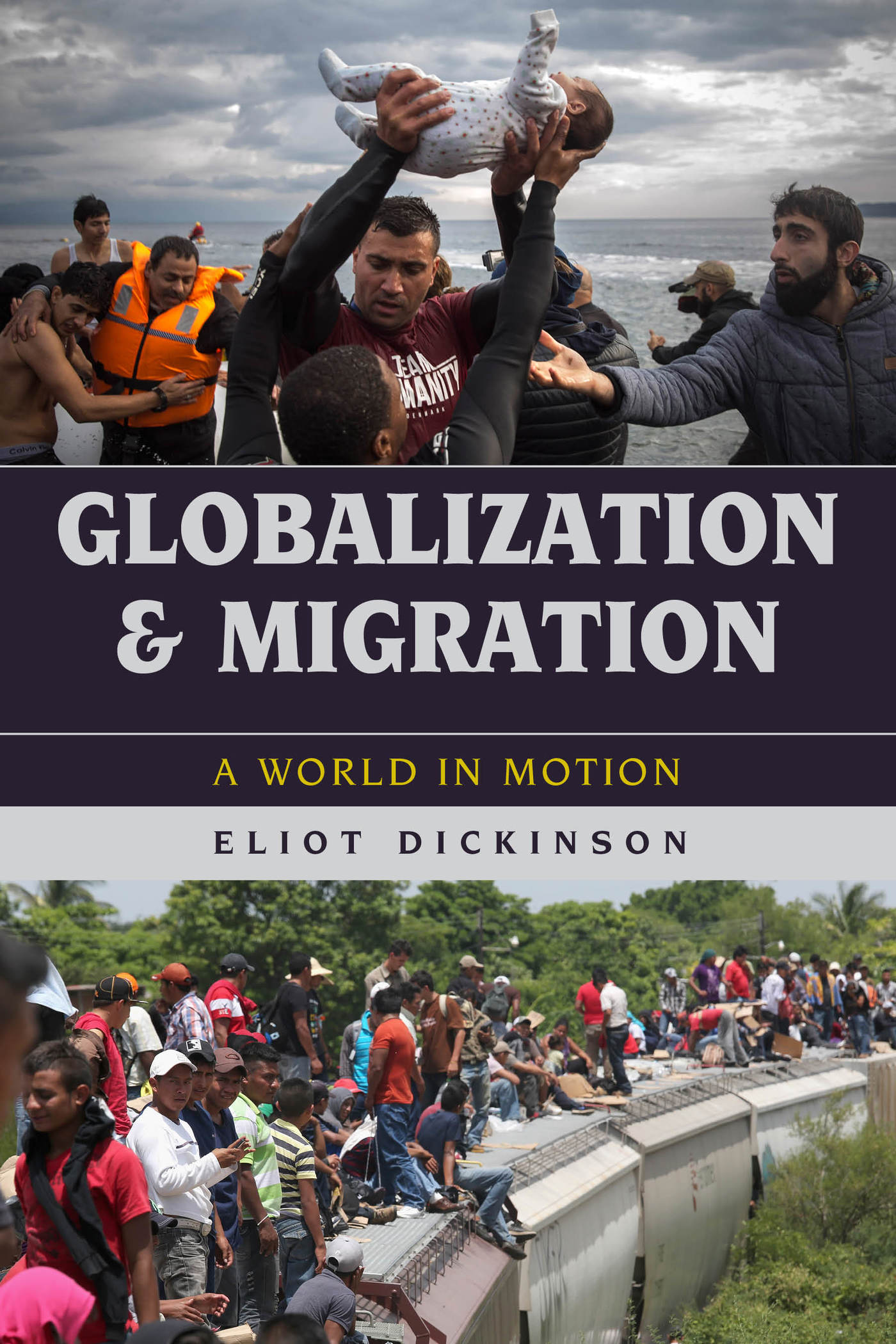
Globalization and Migration Focusing on the intersection between globalization and migration, this text traces a dynamic process that has incorporated millions of migrants into a vast economic marketplace. Dickinson explores the contradictions that make it easier for goods and capital to circulate while simultaneously making it harder for people to migrate. POLITICAL SCIENCE,Globalization

The Sociology of Globalization The new edition of this accessible and wide-ranging book demonstrates the distinctive insights that sociology has to bring to the study of globalization. Taking in the cultural, political and economic dimensions of globalization, the book provides a thorough introduction to key debates and critically evaluates the causes and consequences of a globalizing world. Bringing the discussion right up to date, the new edition includes an increased emphasis on the rise of China, the aftermath of the financial crisis and austerity, the benefits of migration and open borders, and the changing structure of global inequality. Data and literature have been updated throughout the book, with new sections on global cities, the environment and international protests, and expanded discussion of gender. Martell argues that globalization offers many opportunities for greater interaction and participation in societies throughout the world, for instance through the media and migration, but also has dark sides such as conflict, global poverty, climate change and economic insecurity. This book will continue to be an ideal companion to students across the social sciences taking courses that cover globalization, and the sociology of globalization in particular. POLITICAL SCIENCE,Globalization
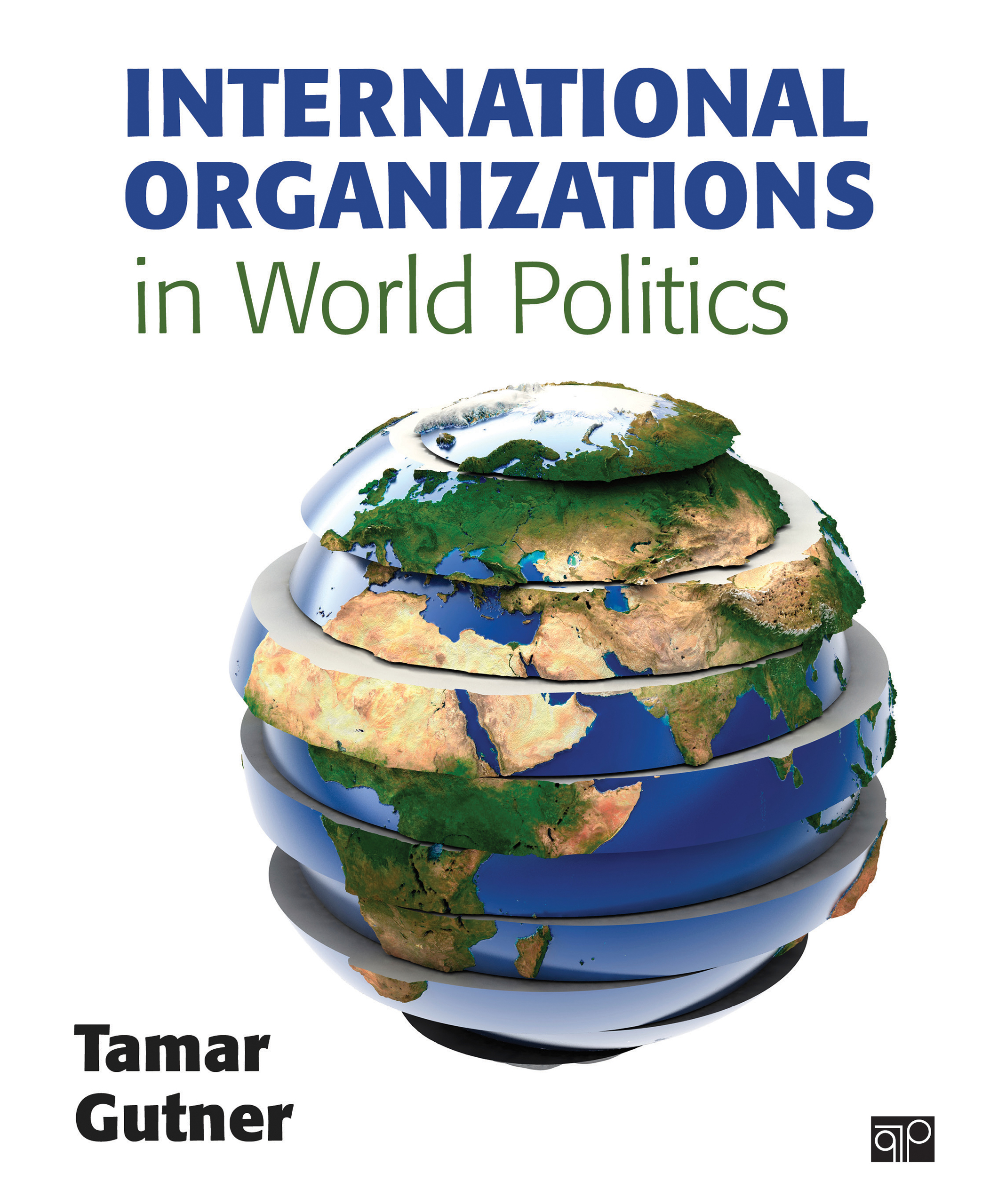
International Organizations in World Politics This timely new title examines the importance and impact of major international organizations and their role in global governance. International Organizations in World Politics focuses on the most influential IOs, including the United Nations, World Bank, International Monetary Fund, and World Trade Organization. For each organization, author Tamar Gutner describes their birth and evolution, governance structure, activities, and performance. A second chapter on each organization presents a case study that illuminates the constraints and challenges each IO faces. Regional organizations and issues are also examined, including the European Union and the euro crisis, as well as a case study on the African Union’s peace operations. POLITICAL SCIENCE,Globalization

Innovation in Emerging Markets Innovation is sweeping the globe at breakneck speed, and emerging markets are where tremendous growth and opportunity reside for the present and future. Jerry Haar and Ricardo Ernst delve into the forces and drivers that shape innovation in emerging markets and present case studies, along with a summation of the key features and outlook for innovation over the next decade. Together with their contributors, they examine innovation as national policy, facilitating institutions- such as universities, research labs, accelerators and incubators, and business associations- and firm-level innovation. They introduce state-of-the-art thinking on innovation by calling upon the experiences of experts in relevant fields, who provide a deeper understanding of the core issues for any person involved in the private sector, academia, or public policy, and intrigued by the challenge and opportunity of innovating in this dynamic global world. The book includes a foreword from Banco Santander. POLITICAL SCIENCE,Globalization

Why Bother With Elections? With the collapse of traditional parties around the world and with many pundits predicting a "crisis of democracy", the value of elections as a method for selecting by whom and how we are governed is being questioned. What are the virtues and weaknesses of elections? Are there limitations to what they can realistically achieve? In this deeply informed book world-renowned democratic theorist Adam Przeworski offers a warts-and-all analysis of elections and the ways in which they affect our lives. Elections, he argues, are inherently imperfect but they remain the least bad way of choosing our rulers. According to Przeworski, the greatest value of elections, by itself sufficient to cherish them, is that they process whatever conflicts may arise in society in a way that maintains relative liberty and peace. Whether they succeed in doing so in today's turbulent political climate remains to be seen. POLITICAL SCIENCE,Globalization
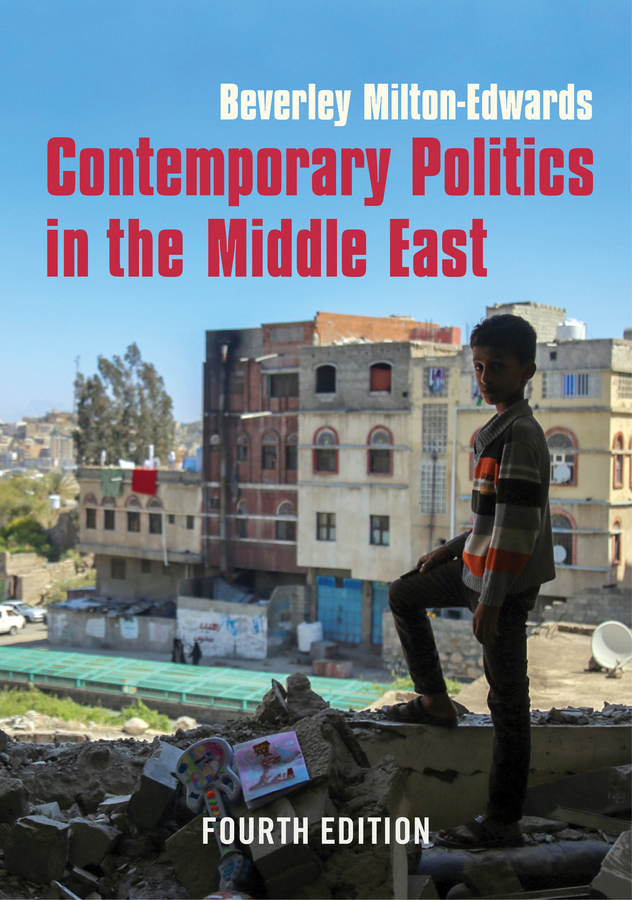
Contemporary Politics in the Middle East The fourth edition of this dynamic and popular text provides a comprehensive introduction to contemporary politics in the Middle East. Fully revised and updated throughout, it features a new chapter on the Arab Spring and its aftermath, plus a wide range of vibrant case studies, data, questions for class discussion and suggestions for further reading. Purposefully employing a clear thematic structure, the book begins by introducing key concepts and contentious debates before outlining the impact of colonialism, and the rise and relevance of Arab nationalism in the region. Major political issues affecting the Middle East are then explored in full. These include political economy, conflict, political Islam, gender, the regional democracy deficit, and ethnicity and minorities. The book also examines the role of key foreign actors, such as the USA, Russia and the EU, and concludes with an in-depth analysis of the Arab uprisings and their impact in an era of uncertainty. POLITICAL SCIENCE,Globalization

Israel / Palestine What explains the peculiar intensity and evident intractability of the Israeli-Palestinian conflict? Of all the "hot spots" in the world today, the apparently endless clash between Jews and Arabs in the Middle East seems unique in its longevity and resistance to resolution. Is this conflict really different from other ethnic and nationalist confrontations, and if so, in what way? In this fully revised and expanded fourth edition of his highly respected introductory text, Alan Dowty demystifies the conflict by putting it in broad historical perspective, identifying its roots, and tracing its evolution up to the current impasse. His account offers a clear analytic framework for understanding transformations over time, and in doing so, punctures the myths of an "age-old" conflict with an unbridgeable gap between the two sides. Rather than simply reciting historical detail, this book presents a clear overview that serves as a road map through the thicket of conflicting claims. Updated to include recent developments, such as the clashes in the Gaza Strip and the latest diplomatic initiatives, the new edition presents in full the opposed perspectives of the two sides, leaving readers to make their own evaluations of the issues. The book thus expresses fairly and objectively the concerns, hopes, fears, and passions of both sides, making it clear why this conflict is waged with such vehemence – and how, for all that, the gap between the two sides has narrowed over time. POLITICAL SCIENCE,Globalization
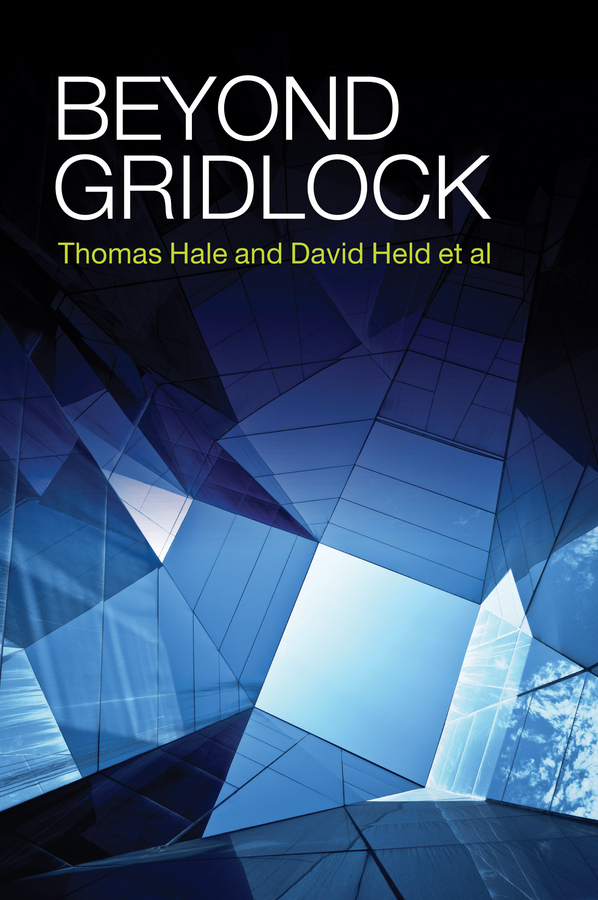
Beyond Gridlock It is now conventional wisdom to see the great policy challenges of the 21st century as inherently transnational. It is equally common to note the failures of the international institutions the world relies on to address such challenges. As the acclaimed 2013 book Gridlock argued, the world increasingly needs effective international cooperation, but multilateralism appears unable to deliver it in the face of deepening interdependence, rising multipolarity, and the growing complexity and fragmentation that characterise the global order. The Gridlock authors have now partnered with a group of leading experts to offer a trenchant reassessment of elements of the argument. Comparing anomalies and exceptions to multilateral dysfunction across a number of spheres of world politics, Beyond Gridlock explores seven pathways through and beyond gridlock. While multilateralism continues to fall short, Beyond Gridlock identifies systematic means to avoid or resist these forces and turn them into collective solutions. This book offers a vital new perspective on world politics as well as a practical guide for positive change in global policy. POLITICAL SCIENCE,Globalization

Globalization and Media The fully updated third edition of this lively and accessible book argues for the central role of media in understanding globalization. By breaking down the economic, cultural, and political impact of media, and through a rich set of case studies from around the globe, Lule describes a divided global village, its destiny shaped by strife. POLITICAL SCIENCE,Globalization
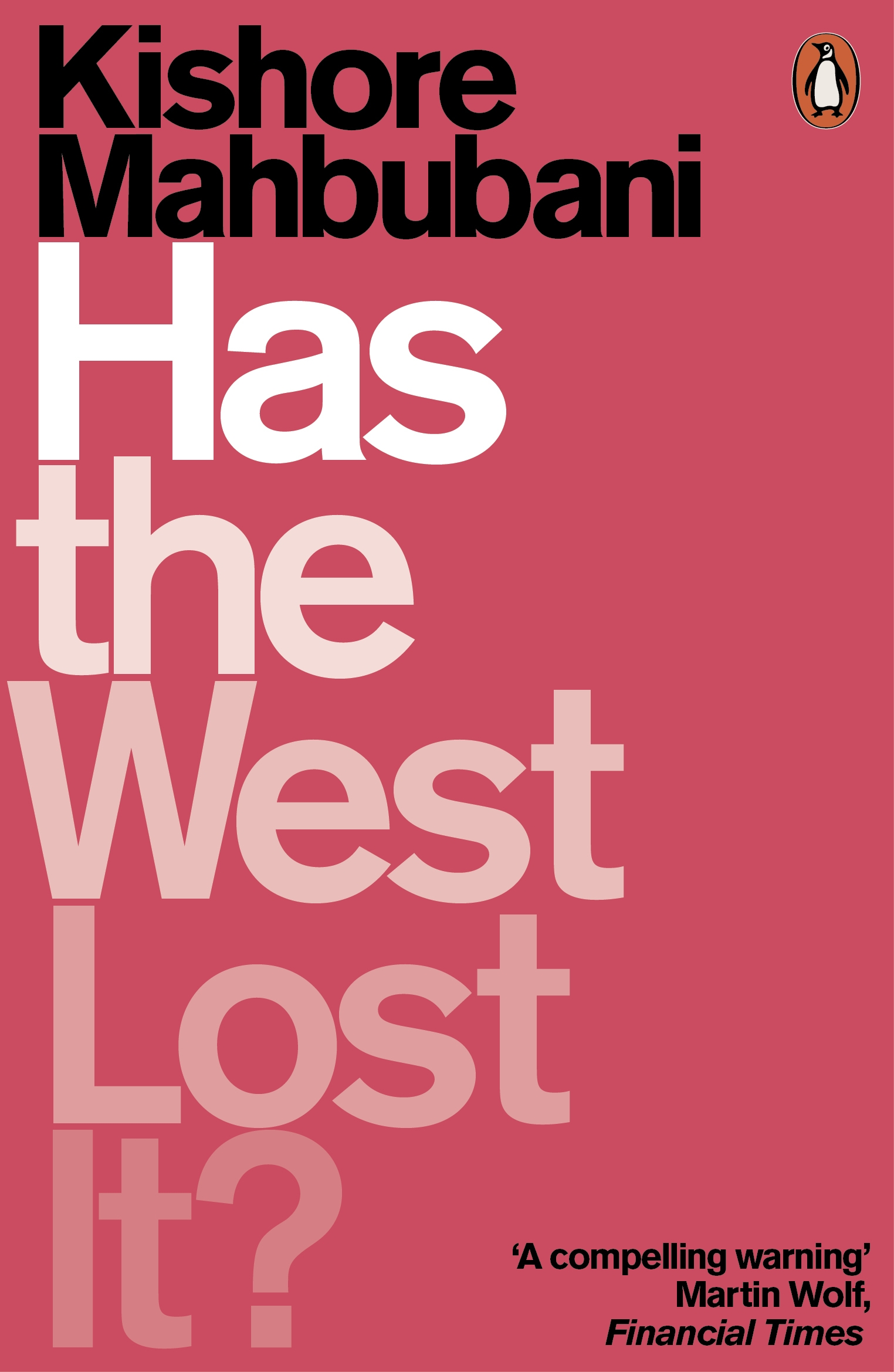
Has the West Lost It? The West's two-century epoch as global powerhouse is at an end. A new world order, with China and India as the strongest economies, dawns. How will the West react to its new status of superpower in decline? In Kishore Mahbubani's timely polemic, he argues passionately that the West can no longer presume to impose its ideology on the world, and crucially, that it must stop seeking to intervene, politically and militarily, in the affairs of other nations. He examines the West's greatest follies of recent times: the humiliation of Russia at the end of the Cold War, which led to the rise of Putin, and the invasion of Iraq after 9/11, which destabilised the Middle East. Yet, he argues, essential to future world peace are the Western constructs of democracy and reason, which it must continue to promote, by diplomacy rather than force, via multilateral institutions of global governance such as the UN. Only by recognising its changing status, and seeking to influence rather than dominate, he warns, can the West continue to play a key geopolitical role. 'Kishore Mahbubani might well be the most intelligent, friendly and doggedly persistent critic of the West. In this brief book, he delivers some of his trademark analysis and pungent observations. We should all think of it as the cold shower that is urgently needed to revive the West' Fareed Zakaria, author of The Post-American World 'A powerful, disputatious book. It's not comfortable reading, and it wasn't meant to be' Paul Kennedy, Director of International Security Studies and Professor of History at Yale University POLITICAL SCIENCE,Globalization

Rethinking Regionalism Since the mid-1980s there has been an explosion of regionalist projects of which the European Union (EU), while the most pervasive example, is but one of many. This major text by a leading authority in the field adopts a thematic approach to provide a reassessment of regionalism and the role of regions in global governance. POLITICAL SCIENCE,Globalization

The Future of Human Rights Human rights have fallen on hard times, yet they are more necessary than ever. People all over the world – from Amazonian villages to Iranian prisons – need human rights to gain recognition, campaign for justice, and save lives. But how can we secure a brighter future for human rights? What changes are required to confront the regime’s weaknesses and emerging global challenges? In this cutting-edge analysis, Alison Brysk sets out a pragmatic reformist agenda for human rights in the twenty-first century. Tracing problems and solutions through contemporary case studies – the plight of refugees, declining democracies such as Mexico and Turkey, the expansion of women’s rights, new norms for indigenous peoples, and rights regression in the USA – she shows that the dynamic strength of human rights lies in their evolving political practice. This distinctive vision demands that we build upon the gains of the human rights regime to construct new pathways which address historic rights gaps, from citizenship to security, from environmental protection to resurgent nationalism, and to globalization itself. Drawing on the author’s extensive experience as a leading human rights scholar and activist, The Future of Human Rights offers a broad and authoritative guide to the big questions in global human rights governance today. POLITICAL SCIENCE,Globalization

Canada and the Challenges of International Development and Globalization A multi-disciplinary and multi-voiced undergraduate textbook linking international development and international studies in a context of globalization, extending to trade, investment, immigration, peacekeeping and combat military interventions, international organizations and people-to-people links. POLITICAL SCIENCE,Globalization
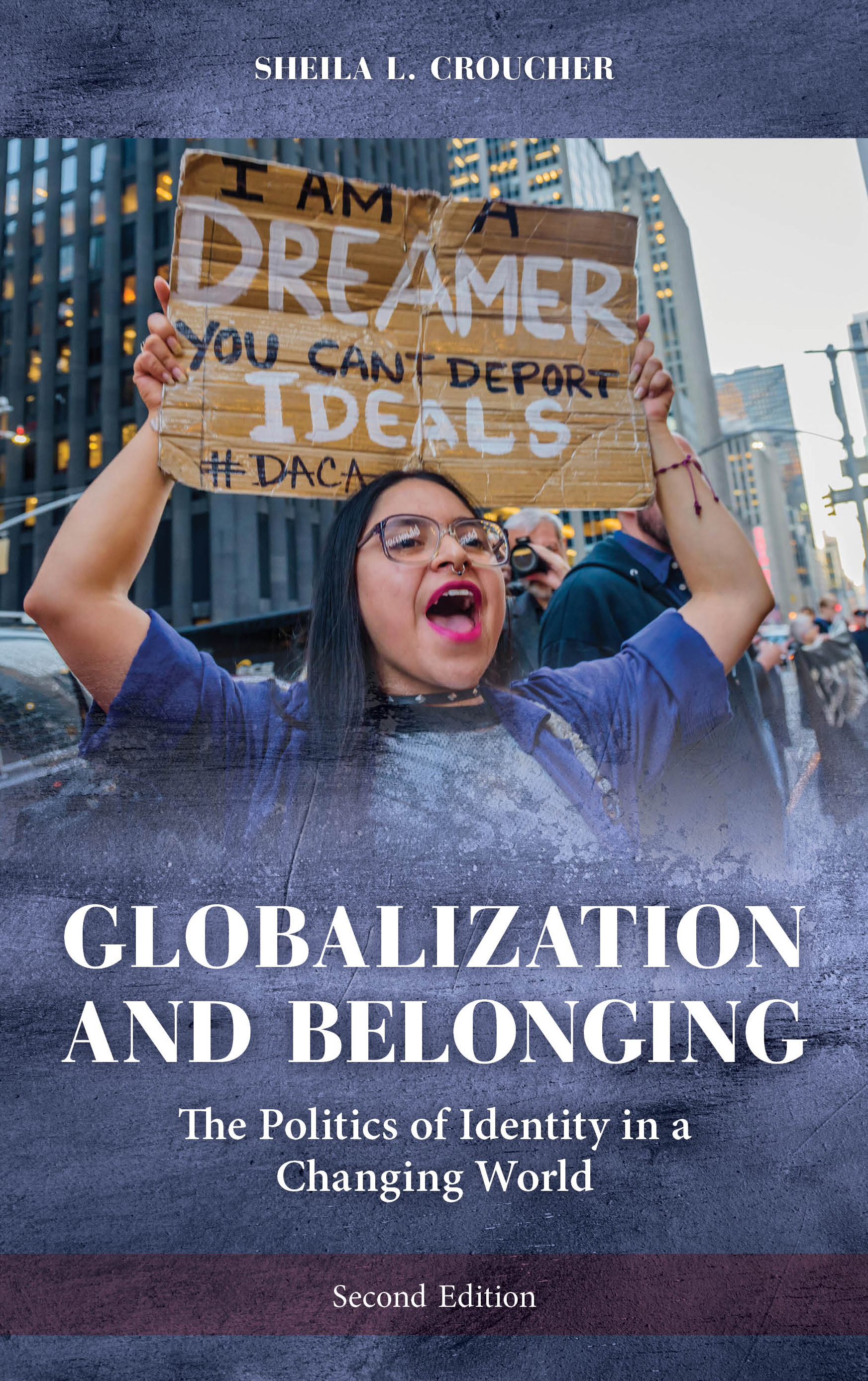
Globalization and Belonging This book examines how globalization shapes the construction of socio-cultural and political attachments and their implications for citizenship, nationhood, ethnicity, and gender. Topics include the commodification of citizenship, the spread of nationalist populism, the rise of ISIS, and women’s transnational activism. POLITICAL SCIENCE,Globalization
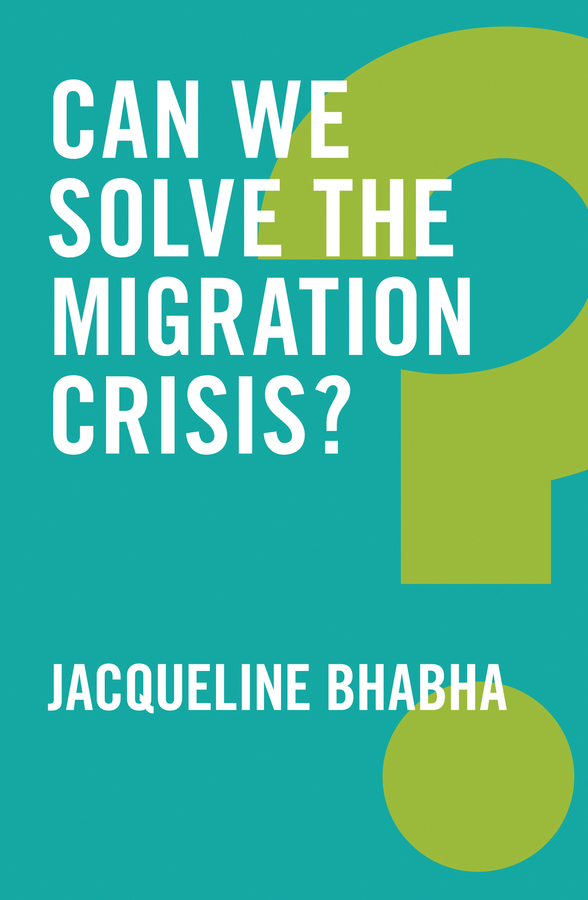
Can We Solve the Migration Crisis? Every minute 24 people are forced to leave their homes and over 65 million are currently displaced world-wide. Small wonder that tackling the refugee and migration crisis has become a global political priority. But can this crisis be resolved and if so, how? In this compelling essay, renowned human rights lawyer and scholar Jacqueline Bhabha explains why forced migration demands compassion, generosity and a more vigorous acknowledgement of our shared dependence on human mobility as a key element of global collaboration. Unless we develop humane 'win-win' strategies for tackling the inequalities and conflicts driving migration and for addressing the fears fuelling xenophobia, she argues, both innocent lives and cardinal human rights principles will be squandered in the service of futile nationalism and oppressive border control. POLITICAL SCIENCE,Globalization

United in Discontent Cosmopolitanism is often discussed in a critical and disapproving manner: as a concept complicit with the interests of the powerful, or as a notion related to Western political supremacy, the ills of globalization, inequality, and capitalist economic penetration. Seen as the moral justification for embracing or tolerating cultural difference, ethnically and socially diverse communities unenthusiastic with change, develop an acknowledgement of their common position vis-à -vis a western, “universal†political point of view. By means of exploring the idiosyncratic form of political intimacy generated by anti-cosmopolitanism, and assuming an analytical and critical stance towards the concepts of parochialism and localism, this volume examines the political consciousness of such negatively predisposed actors, and it attempts to explain their reservation towards the sincerity of international politics, their reliance on conspiracy theories or nationalist narratives, their introversion. POLITICAL SCIENCE,Globalization
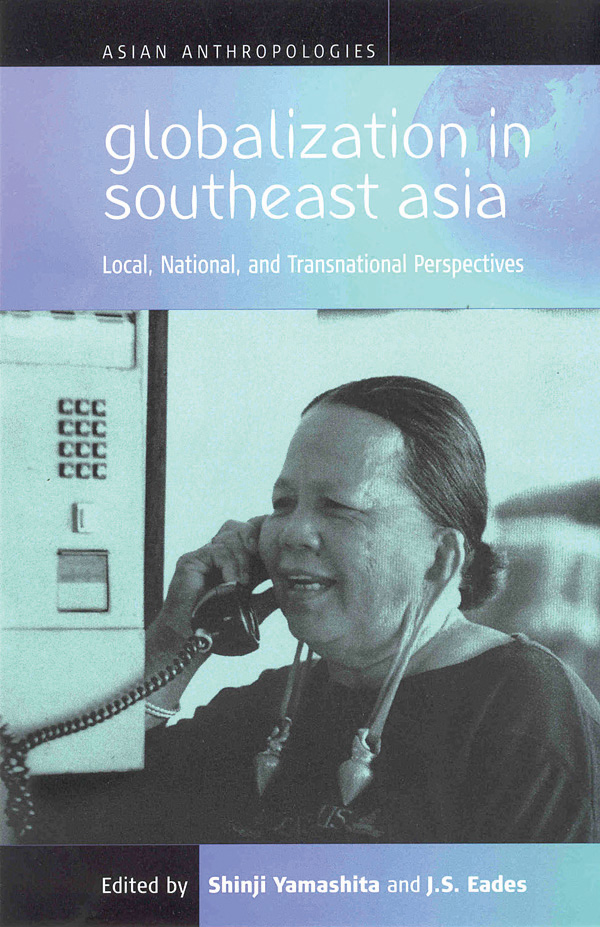
Globalization in Southeast Asia The rapid postwar economic growth in the Southeast Asia region has led to a transformation of many of the societies there, together with the development of new types of anthropological research in the region. Local societies with originally quite different cultures have been incorporated into multi-ethnic states with their own projects of nation-building based on the creation of "national cultures" using these indigenous elements. At the same time, the expansion of international capitalism has led to increasing flows of money, people, languages and cultures across national boundaries, resulting in new hybrid social structures and cultural forms. This book examines the nature of these processes in contemporary Southeast Asia with detailed case studies drawn from countries across the region, including Indonesia, Malaysia, the Philippines, Singapore and Thailand. At the macro-level these include studies of nation-building and the incorporation of minorities. At the micro-level they range from studies of popular cultural forms, such as music and textiles to the impact of new sects and the world religions on local religious practice. Moving between the global and the local are the various streams of migrants within the region, including labor migrants responding to the changing distribution of economic opportunities and ethnic minorities moving in response to natural disaster. POLITICAL SCIENCE,Globalization

European Products On the Mediterranean island of Cyprus, rural villages, traditional artefacts, even atmospheres and experiences are considered heritage. Heritage making not only protects, but also produces, things, people, and places. Since the Republic of Cyprus joined the European Union in 2004, heritage making and Europeanization are increasingly intertwined in Greek-Cypriot society. Against the backdrop of a long-term ethnographic engagement, the author argues that heritage emerges as an increasingly standardized economic resource, a “European product.†Implemented in historic preservation, rural tourism, culinary traditions, nature protection, and urban restoration projects, heritage policy has become infused with transnational market regulations and neoliberal property regimes. POLITICAL SCIENCE,Globalization
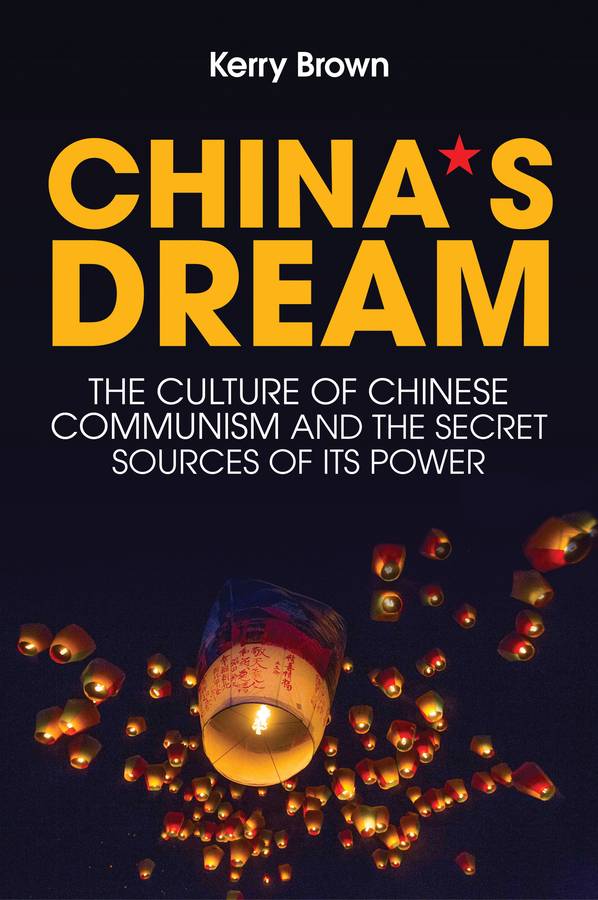
China's Dream The Communist Party of China (CPC) is one of the great political forces of modern times. In charge of the destiny of a fifth of humanity, it survives despite the collapse of similar systems elsewhere. Few, however, understand the sources of this resilience, or, for that matter, what the Party itself stands for. China’s Dream is the first book to explore the Communist Party as a cultural, rather than a political, entity. It looks at the narratives the Party has created to recount its own history, with the moral story about national rejuvenation and renaissance that these encode. It does not shy away from the thorny issue of how a Party under Mao Zedong, one associated with self-sacrifice, collectivist effort, and anti-individualism, came to pragmatically embrace market capitalism and a new ethics. The tensions to which this gives rise have resulted in a crisis of values, which is now being addressed – with very mixed results – by the CPC. Drawing on his extensive knowledge of contemporary China, Kerry Brown takes us on a unique and fascinating journey through the least understood aspect of China today – not the great economic revolution in the material world, but the deep cultural revolution already underway in Chinese people’s daily lives. POLITICAL SCIENCE,Globalization

Football Football is the most popular sport on the planet partly because it’s so simple to play – but as philosopher, novelist and avid fan Stephen Mumford shows, behind the straightforward rules of the game there lurks a world of intriguing complexity. Mumford considers the intellectual basis upon which football rests, guiding readers through a number of issues at the heart of the game. How can a team be greater than the sum of its individual players? What is the essential role of chance? Should we want to win at all costs? What does it mean to control space? And can true beauty be found in football? Rich with colourful examples from football’s past and present, Mumford’s book is both a love letter to football and a reflection on its enduring capacity to enthral and excite. POLITICAL SCIENCE,Globalization

Globalization and Culture Now updated with new chapters on culture and populism, Globalization and Culture argues that we are witnessing the formation of a global mélange culture through processes of cultural mixing. Its historically deep and geographically wide approach to globalization is essential reading as we face the increasing spread of conflicts bred by cultural misunderstanding. POLITICAL SCIENCE,Globalization

The Influence of Soros A seasoned journalist probes one of the right-wing’s favorite targets, Hungarian-American investor and philanthropist George Soros, to explore the genesis of his influence and the truth of the conspiracies that surround him. For years, hedge fund tycoon George Soros has been demonized by GOP politicians, fringe outlets, and right-wing media personalities, who claim Soros often manipulates the global economy and masterminds the radical left. He has been accused of using his billions to foment violence, support “white genocide,†and pay migrants to seek asylum in the United States. Right-wing media personalities have described him as working to hijack our democracy and undermine sovereignty. Left-leaning outlets, meanwhile, have suggested that his philanthropy is a distraction from the economic misery he himself has made. But who is George Soros? How did he make his money? What causes does he actually support? How did this billionaire become the right’s favorite target—used by elected officials sympathetic to the idea that their country’s opposition can be blamed on one man in the endless messaging war? How much of the hatred is driven by rising antisemitism? Though his name appears often in the media, most people know little about Soros. Weaving biography, cultural commentary, and investigative reporting, Emily Tamkin brings into focus the man and his myth to examine how much influence he actually has on politics. Is Soros simply a left-wing version of the Koch brothers? Or is he genuinely trying to make the world a better place? The Influence of Soros offers an understanding of the man and his money, his contributions and donations, and his true sway over our politics, elections, and our societies. Ultimately, Tamkin asks, can a truly open society exist if any one man can have the kind of power Soros wields? POLITICAL SCIENCE,Globalization
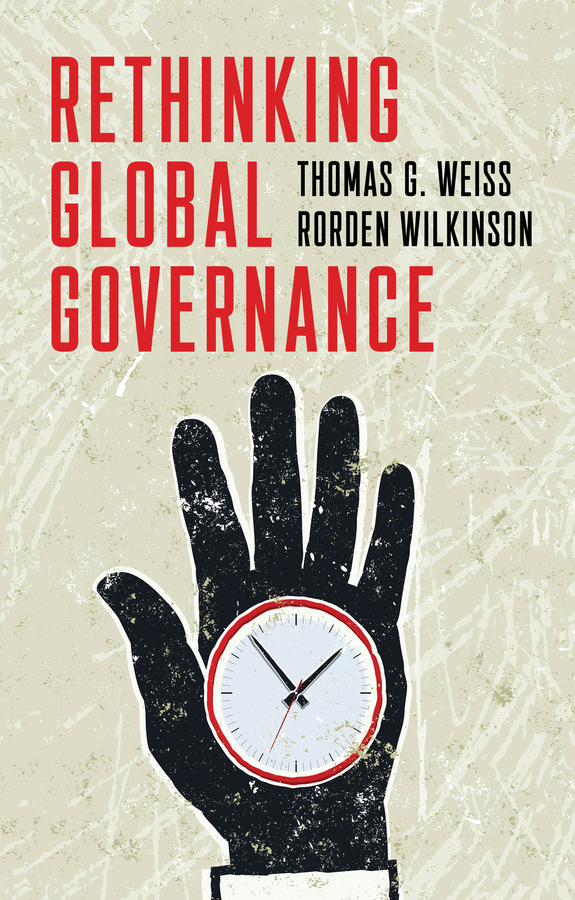
Rethinking Global Governance Rethinking Global Governance casts fresh eyes upon a once poignant but now languishing concept. Its purpose is to disrupt the simple association between global governance and the actions and activities of international organizations in the post-Cold War era and to focus instead on a set of questions that probe the intricate and multifaceted manner in which the world is governed. The book moves beyond the ubiquity and imprecision that has plagued the term and offers an intellectual framework with the potential to improve both thinking and practice. Building on the analytical insights of two of the leading scholars in the field, Rethinking Global Governance provides an antidote to simplistic usage and an authoritative yet readable attempt to grasp the governance of our globe — past, present, and future. POLITICAL SCIENCE,Globalization

Crossing Borders Crossing Borders provides a framework built upon an understanding of the many borders that define the international system. Renowned authors Harry I. Chernotsky and Heidi H. Hobbs address many of the different fields that constitute international studies—geography, politics, economics, sociology, and anthropology—and give instructors a starting point from which they can pursue their own disciplinary interests. By integrating research and current examples, the Third Edition encourages you to identify your role in today’s international arena and what it means to be a global citizen. Not only do you develop a better understanding of the world, you also receive advice on how to increase your own global engagement through study abroad, internships, and career options. This Third Edition is thoroughly updated to reflect recent events and trends, including cyberterrorism, the rise of ISIS, and other key issues. It offers new color maps and clear learning objectives for every chapter, giving students a solid understanding of the complexity of the issues facing the world today. POLITICAL SCIENCE,Globalization

International Studies The challenge of teaching international studies is to help you think coherently about the multiple causes and effects of global problems. In International Studies: Global Forces, Interactions, and Tensions, award-winning scholars Scott Straus and Barry Driscoll give you a clear framework that pinpoints how key factors—forces, interactions, and tensions—contribute to world events, with both global and local consequences. The authors first show you how to look for common patterns in global issues by introducing four world-shaping forces: global markets, shifting centers of power, information and communications technologies, and global governance. They systematically trace how these forces prompt interactions among world actors and thus give rise to a set of tensions that spur key challenges. The framework enables you to ask and answer for yourself—Who is interacting? Where did such interactions develop? What policies or institutions govern them? Why are they getting certain global and local reactions? You are then apply the framework to the global problems that matter most to you: human rights abuses, economic inequality, terrorism, forced migration, pandemics and global health responses, climate change, food security, and more. International Studies raises the bar for the Introduction to IS course, moving beyond interdisciplinary, and into the realm of critical analysis to increase student relevancy and motivation. POLITICAL SCIENCE,Globalization
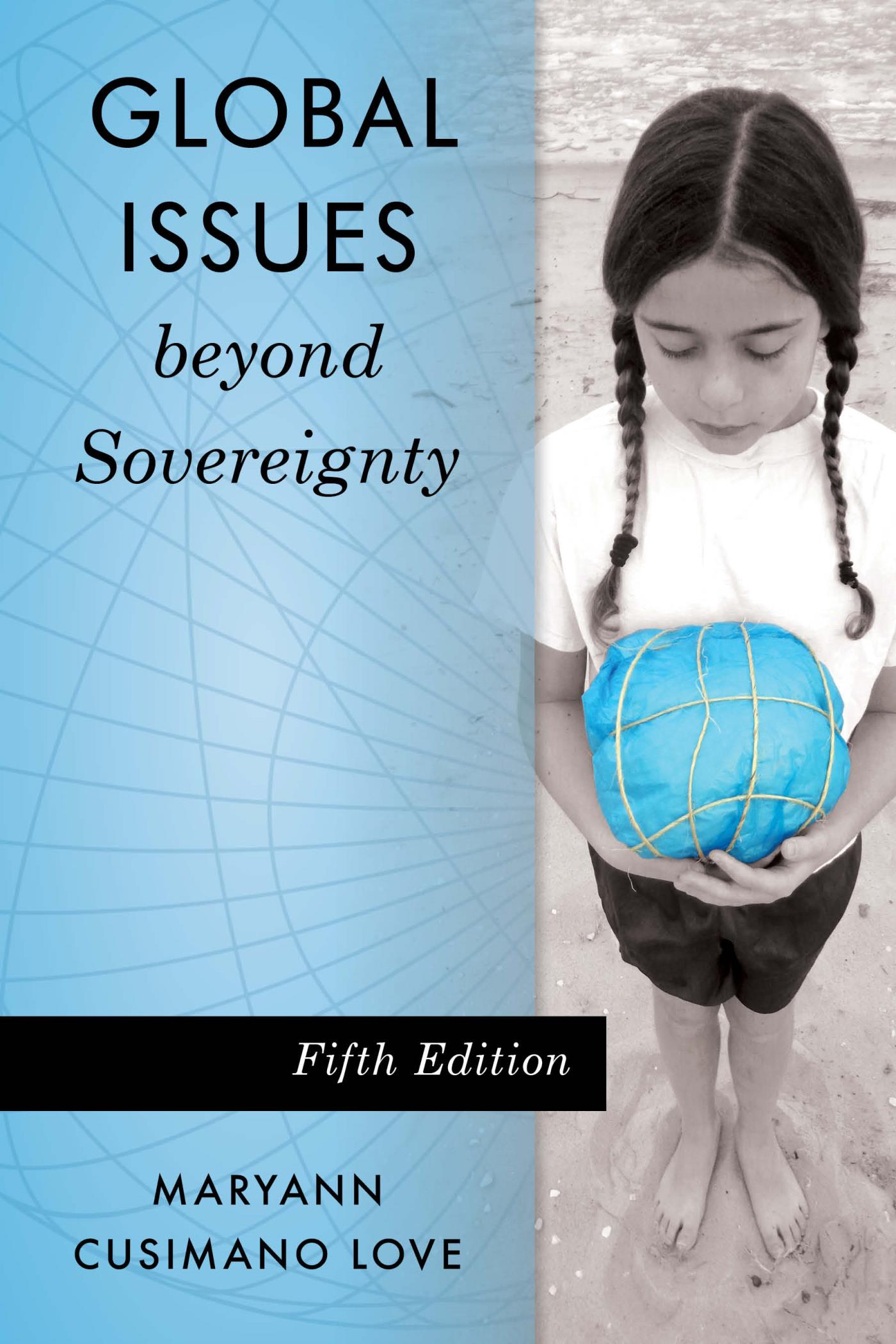
Global Issues beyond Sovereignty This book compares and discusses a range of responses to managing global issues. The three channels that global issues flow through (public sector responses, private sector responses, and mixed public-private sectors) are explored in detail for undergraduate students, with lessons learned from the responses presented to enhance theory and practice. POLITICAL SCIENCE,Globalization
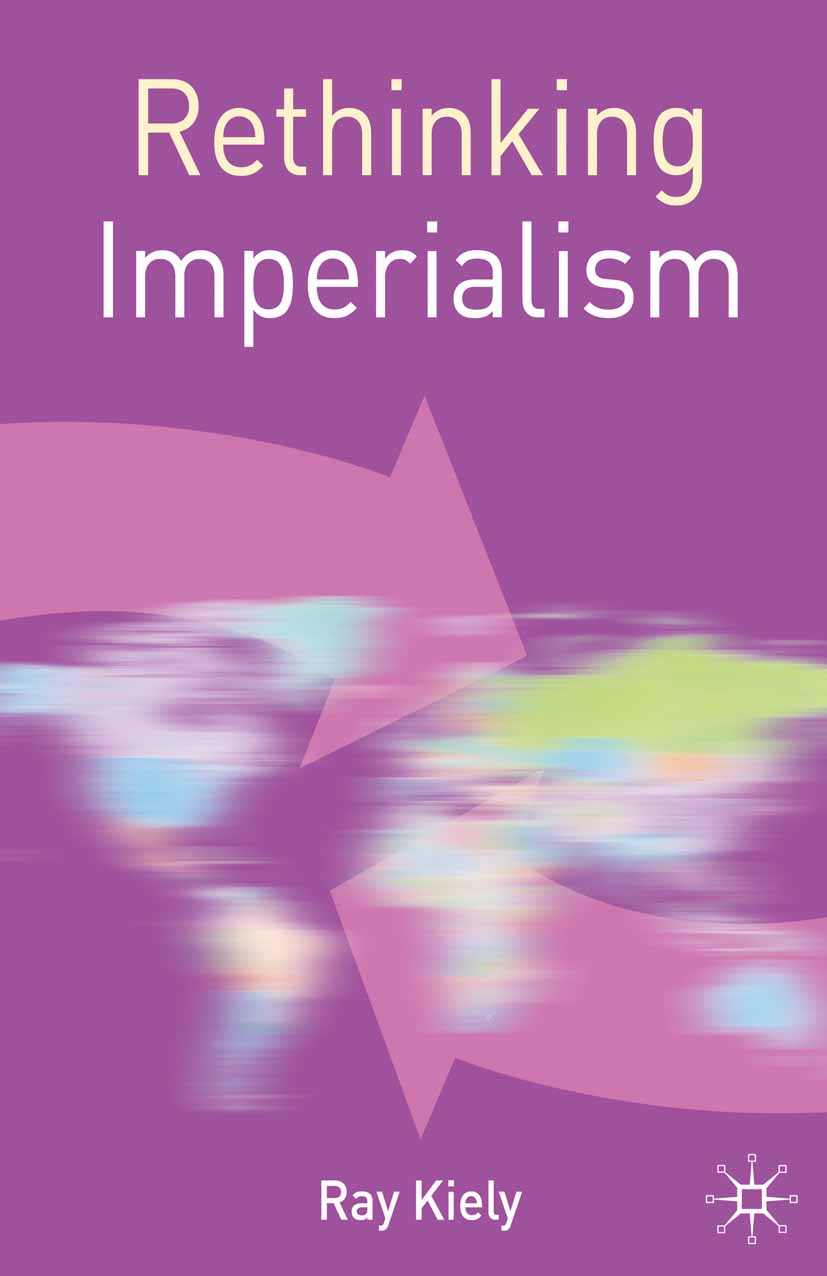
Rethinking Imperialism Imperialism has become a key focus of debate about world politics in the post-9/11 world. This major new text provides a systematic reappraisal of the evolution of the phenomenon and the concept from the 19th century as the basis for a reassessment of Globalization and US hegemony in the world today. POLITICAL SCIENCE,Globalization
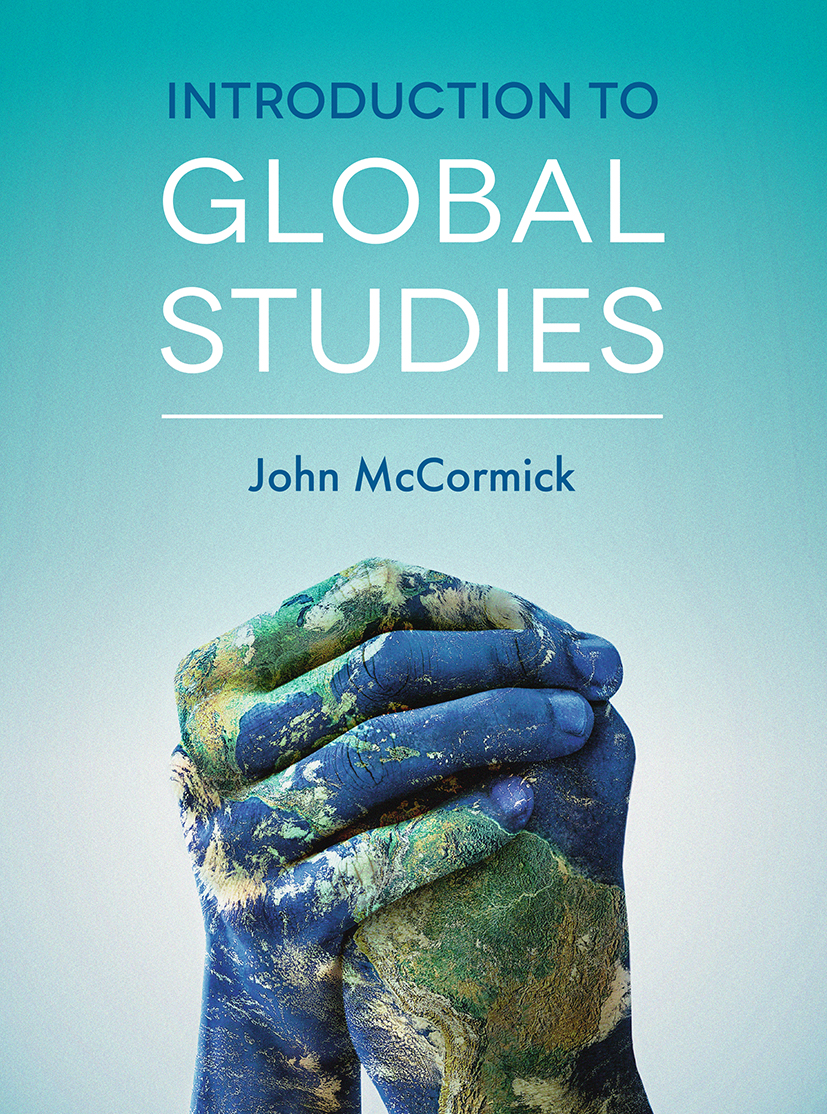
Introduction to Global Studies This textbook provides a multidisciplinary introduction to Global and International Studies. Offering unrivalled breadth and depth, it covers all the key dimensions of the topic, including broad introductions to international politics and economics, and focused surveys of topics from human rights and migration to conflict and the environment. John McCormick’s lucid writing style renders complex information understandable to all students. Full-colour photographs, maps, tables and figures bring the subject to life and innovative pedagogical features emphasize the importance of understanding perspectives and experiences different from one’s own worldview. Assuming no prior knowledge of the subject, this textbook is ideal for undergraduate students worldwide who are taking introductory modules in Global and International Studies. The text can also be used by undergraduate students taking courses on Globalization. POLITICAL SCIENCE,Globalization
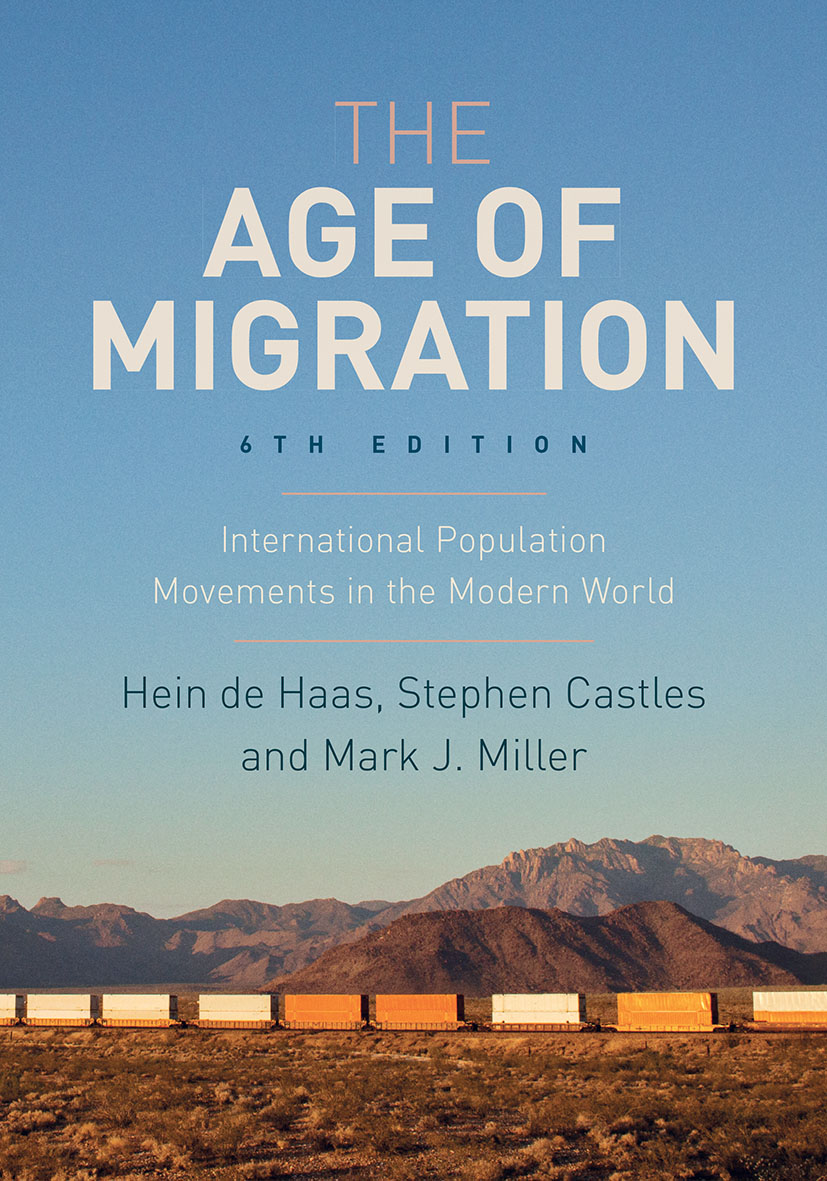
The Age of Migration Long established as the leading textbook on migration and used by students and scholars alike all over the world, this fully revised and updated sixth edition continues to offer an authoritative and cutting-edge account of migration flows, why they occur, and their consequences for both origin and destination societies. International migration is one of the most emotive issues of our times, reforging societies around the world and shaping debates on security, national identity and sovereignty in profound ways. The expert authors of this book provide a truly global and interdisciplinary introduction to this perennially important topic, with chapters covering all of the world’s regions and spanning the nineteenth century to the present day. Exploring the significance of migration in relation to recent events and emerging trends, from the policies of the European Union to the Great Recession, this text helps to shed light on the often large gap between the rhetoric and realities of migration. For students of migration studies in disciplines as wide ranging as Politics, Sociology, Geography, Area Studies, Anthropology and History this is an indispensable guide, whether already familiar with the subject matter or approaching the topic for the first time. The Age of Migration is published by Macmillan Education. In the United States and its dependencies, Canada, Mexico and the Philippines, it is distributed under licence by Guildford Press. https://www.guilford.com/books/The-Age-of-Migration/Castles-Haas-Miller/9781462513116 POLITICAL SCIENCE,Globalization
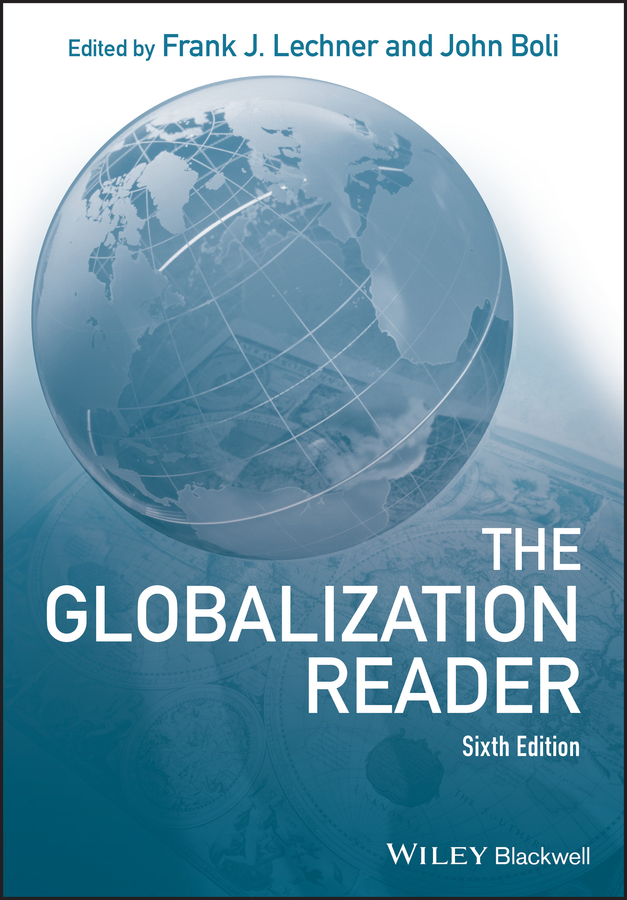
The Globalization Reader An introduction to the issues surrounding the complex and controversial realities of today's interconnected world, the revised sixth edition Since its initial publication, The Globalization Reader has been lauded for its comprehensive coverage of the issues surrounding globalization. Now in its sixth edition, the Reader has been thoroughly revised and updated and continues to review the most important global trends. Including readings by a variety of authors, the text offers a wide-ranging and authoritative introduction to the political, economic, cultural, and experiential aspects of globalization. The updated sixth edition presents the most accessible and comprehensive review of current debates and research. Contributions from scholars, activists, and organizations provide balanced viewpoints and expert coverage of the many aspects of globalization. The Globalization Reader offers readings on an exciting range of new topics as well as retaining key globalization topics such as the experience of globalization, economic and political globalization, the role of media and religion in cultural globalization, women’s rights, environmentalism, global civil society, and the alternative globalization movement. This important resource: Covers the many complex dimensions of globalization Includes contributions from many of the most prominent globalization scholars Presents concise and informative introductions to each major topic Offers compelling discussion questions for each section Contains readings on a variety of new topics such as migration, medical tourism, state policy regarding abortion and same-sex sexual relations, the UN Global Compact, climate justice, and more Written for students in undergraduate and graduate courses in sociology, political science, anthropology and geography, the revised sixth edition covers courses such as globalization, comparative political economy, international relations and similar topics. POLITICAL SCIENCE,Globalization

Sovereignty Suspended Rebecca Bryant and Mete Hatay develop the concept of the aporetic state to describe an entity that acts like a state even as nonrecognition renders it unrealizable. They argue that only by rethinking the de facto state as a realm of practice will we be able to understand the longevity of such states and what it means to live in them. POLITICAL SCIENCE,Globalization
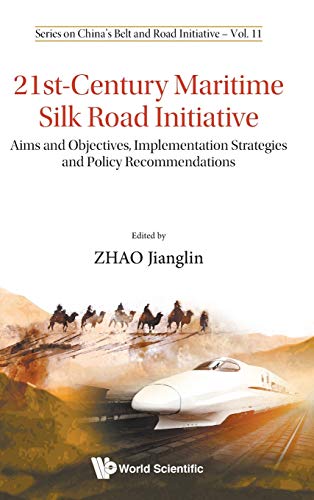
21st-century Maritime Silk Road Initiative The concept of a '21st-Century Maritime Silk Road' refers to the proposed modern-time version of the ancient Maritime Silk Road that connected China with the rest of Asia, and even parts of eastern Africa. It is a strategic initiative designed to increase investments in and foster collaboration among all countries along the ancient Silk Road. This volume, 21st-Century Maritime Silk Road Initiative: Aims and Objectives, Implementation Strategies and Policy Recommendations, presents the latest research findings on the directions and implementation methods related to the initiative, and contributors offer policy suggestions, include promoting effective macroeconomic policies, extending microeconomic cooperation schemes, removing trade barriers and facilitating financial integration, building infrastructures that can connect all subregions in Asia, and increasing people-to-people exchanges and industrial cooperation. POLITICAL SCIENCE,Globalization
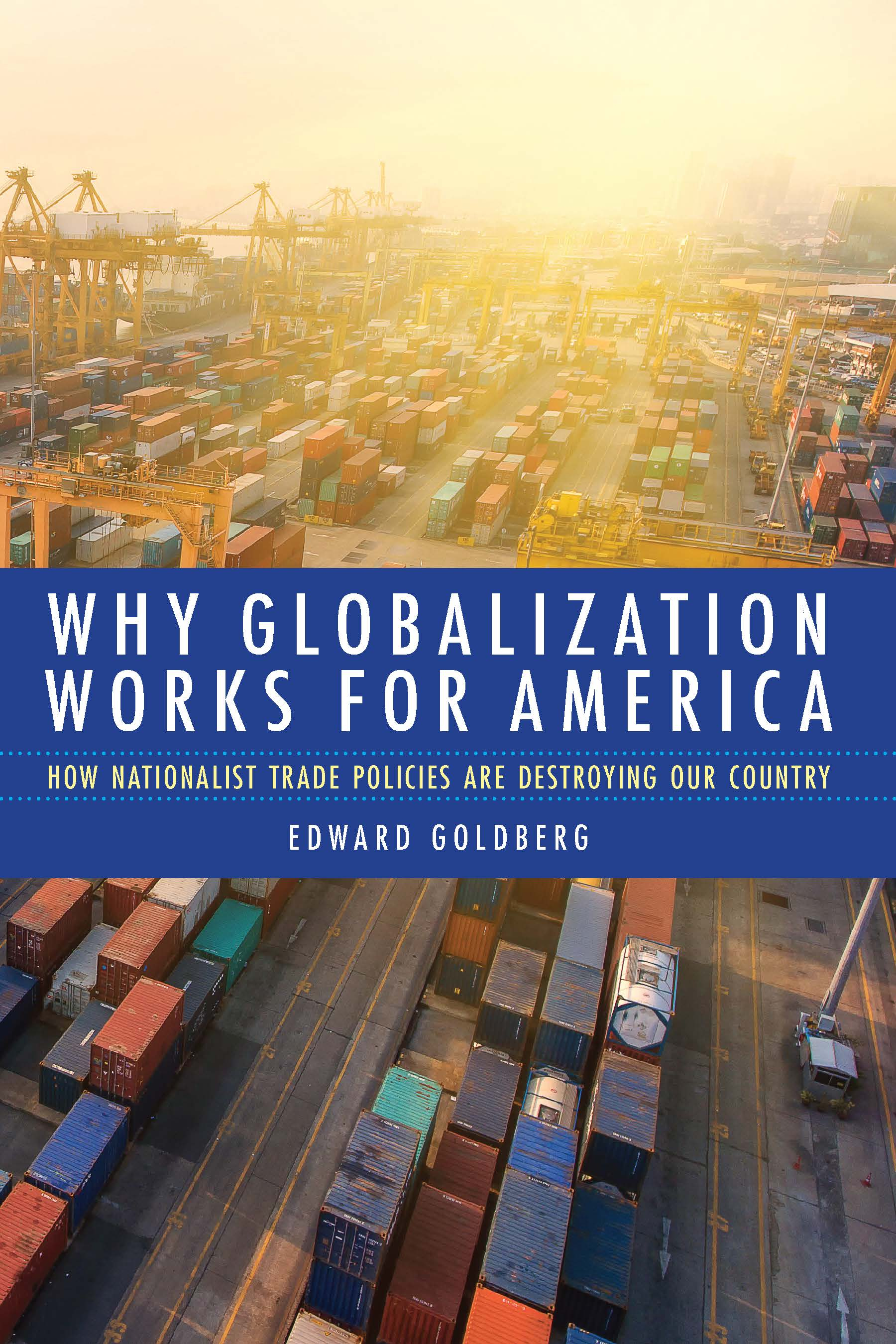
Why Globalization Works for America Blue-collar job loss, immigration, trade deficits—Americans blame globalization for a host of problems. Indeed, even in a political system split by fundamental divisions, populists and progressives alike belong to a chorus that decries globalization’s effects on our politics, way of life, and interactions with the world. Yet the United States is the biggest beneficiary of the global economy it has helped to create. Edward Goldberg argues that globalization is the economic and cultural version of evolution, a natural process that pushes people into more efficient behavior influenced by the market and our human need to explore, change, and grow. Properly implemented, it propels cultures and societies forward as one new idea challenges or blends into another. Harmful nationalist policies have arisen because Americans do not equally share globalization’s benefits, a situation made worse by the government’s refusal to implement policies that would mitigate the rampant inequalities. A bold challenge to popular opinion, Why Globalization Works for America offers a historically informed analysis of why we should celebrate globalization’s place in our lives. POLITICAL SCIENCE,Globalization
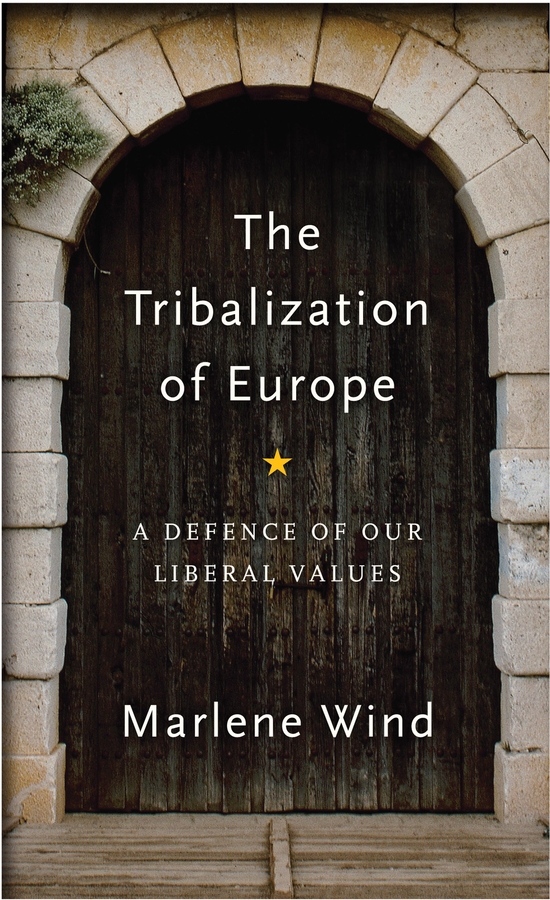
The Tribalization of Europe Tribalization is a global megatrend in today’s world. The election of Donald Trump, the Brexit vote, populist movements like Catalan separatism – together with democratic backsliding in Central and Eastern Europe – are all examples of tribalization. Fuelled by anti-globalism and identity politics, tribalization is drawing up the drawbridge to the world. It is putting cultural differences before dialogue, collaboration and universal liberal values. But tribalism is a dangerous road to go down. With it, argues Marlene Wind, we have put democracy itself in danger. Tribalism is not just about being pro-nation, anti-EU and anti-global. It is in many instances a bigger and more fundamental movement that casts aside the liberal democratic principles we once held in common. At a time when former defenders of liberal values are increasingly silent or have even joined the growing chorus of tribalists, this book is a wakeup call. Drawing on a wide range of examples from the UK and the US to Spain, Hungary and Poland, Wind highlights the dangers of identity politics and calls on people to stand up for democracy and the rule of law. POLITICAL SCIENCE,Globalization
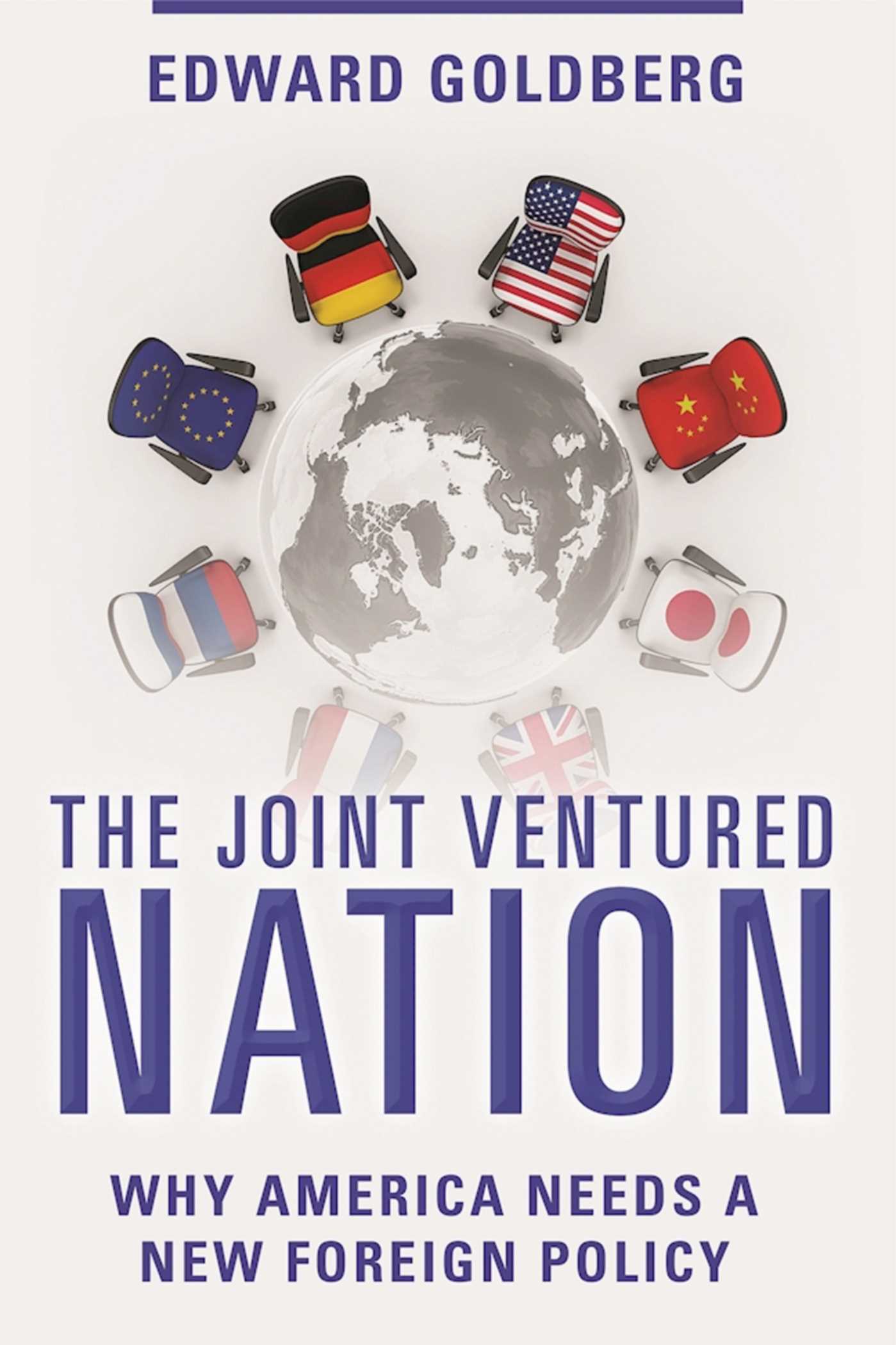
The Joint Ventured Nation Moving America from the Troubled Superpower to the Indispensable Partner What a ride the world has been on over the last thirty years: the fall of the Berlin Wall, China’s reemergence as a major power, the wishful creation of the BRICS, technological innovations, 9/11, conflicts in Iraq, Afghanistan, and Syria, terrorism, the market crash of 2008, the Arab Spring, the Eurozone crisis, America’s reemergence as an energy giant, and the rebirth of czarist Russia, and now the election of Donald Trump. The most important change, thoughand the key to America’s future, despite Trump’s campaign rhetoricis globalization. Our fate is now interconnected to other major industrial countries, yet our foreign policy has not adapted to this reality. In today’s world, the term ally†is becoming rapidly irrelevant. The United Kingdom is an old ally of America, but as a result of economic codependencies, China is now much more important to the United States. Instead of thinking in terms of allies, think of US policy regarding other twenty-first-century nations as a set of concurrent joint venture agreements. In The Joint Ventured Nation, author Edward Goldberg argues that American foreign policy is too focused on a world that no longer exists, one in which political power is measured by military strength or fervent ideology. He details how our fate is now intertwined with our economic partners, and looks at how we should deal with states such as Russia and the various Middle Eastern nations that refuse to join the globalized world. Most importantly, he shows how America can remain first among equals in a joint ventured world. POLITICAL SCIENCE,Globalization

Modern Consuls, Local Communities and Globalization This book offers a tool in international relations conducted separately from the activities of ambassadors and other diplomats at the highest level of diplomacy at embassies in capital cities. In communities around the world, foreign consuls provide a local link to the modern arena of global activities. To be credible players in the international community, educational, civic and business leaders have to understand the role and nature of a variety of named consuls (such as a career consul, honorary consul, consul general, vice consul, head of post, and trade commissioner) and their official functions in various locations throughout a nation. The book also presents the international rules of consular diplomacy, such as rank and titles determining consular precedence to provide guidelines in areas with an active consular corps. Lastly, the book clarifies the difference between citizens on their government’s career consular track and those (mostly co-nationals) who function as honorary consuls. POLITICAL SCIENCE,Globalization

The Routledge Handbook of Transformative Global Studies The Routledge Handbook of Transformative Global Studies provides diverse and cutting-edge perspectives on this fast-changing field. For 30 years the world has been caught in a long ‘global interregnum,’ plunging from one crisis to the next and witnessing the emergence of new, vibrant, multiple, and sometimes contradictory forms of popular resistance and politics. This global ‘interregnum’ – or a period of uncertainty where the old hegemony is fading and the new ones have not yet been fully realized – necessitates critical self-reflection, brave intellectual speculation and (un)learning of perceived wisdoms, and greater transdisciplinary collaboration across theories, localities, and subjects. This Handbook takes up this challenge by developing fresh perspectives on globalization, development, neoliberalism, capitalism, and their progressive alternatives, addressing issues of democracy, power, inequality, insecurity, precarity, wellbeing, education, displacement, social movements, violence and war, and climate change. Throughout, it emphasizes the dynamics for system change, including bringing post-capitalist, feminist, (de)colonial, and other critical perspectives to support transformative global praxis. This volume brings together a mixture of fresh and established scholars from across disciplines and from a range of both Northern and Southern contexts. Researchers and students from around the world and across the fields of politics, sociology, international development, international relations, geography, economics, area studies, and philosophy will find this an invaluable and fresh guide to global studies in the 21st century. POLITICAL SCIENCE,Globalization
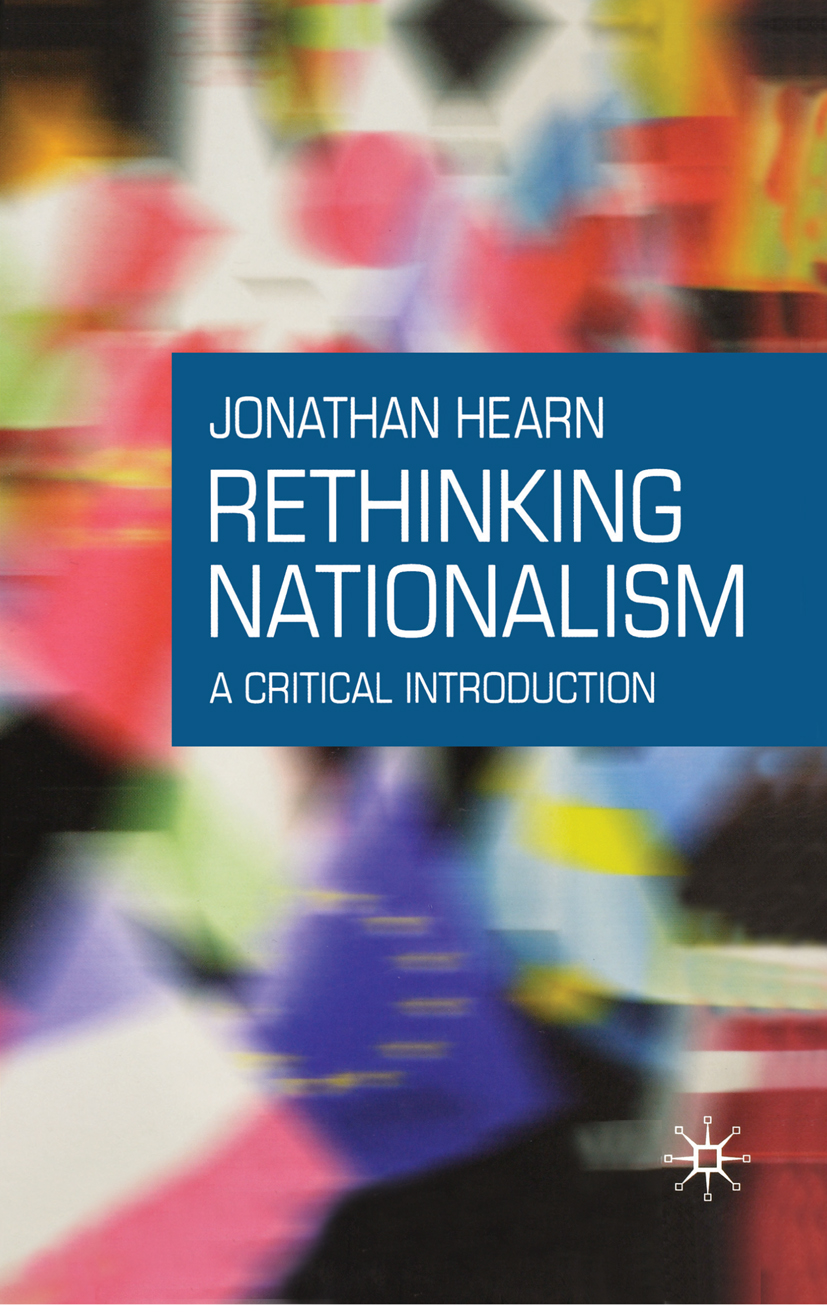
Rethinking Nationalism This is an innovative and interdisciplinary introduction to the study of nationalism. The author uses paired chapters, first to present the work of key authors in relation to each of a set of key themes - primordialism, modernism, power and culture - and then critically to rethink these core concepts. POLITICAL SCIENCE,Globalization
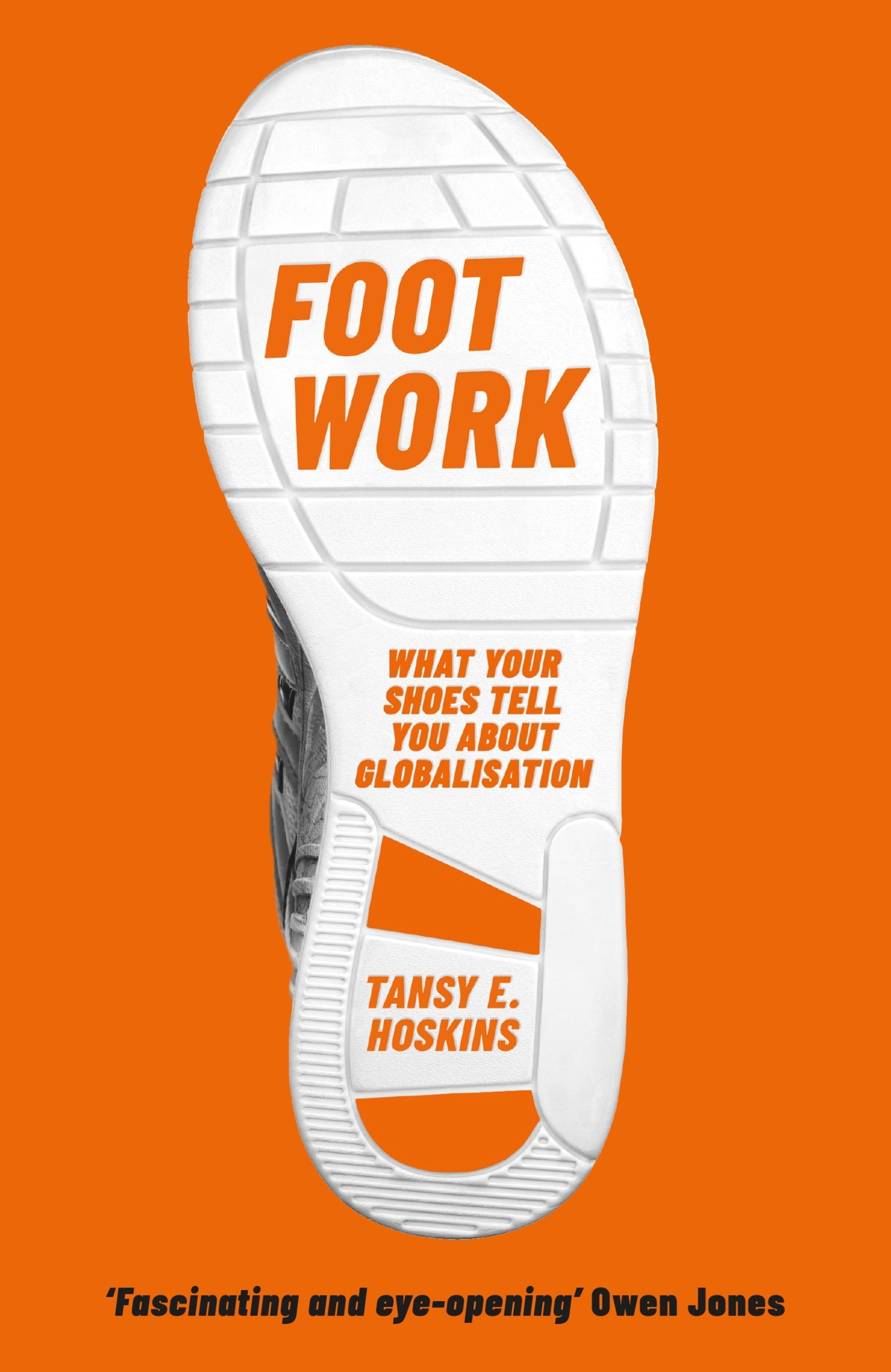
Foot Work From the author of STITCHED UP: 'Makes a strong case for nothing less than a revolution' Emma Watson 'A superb primer on everything that is wrong with our world - and how we can start to change it' NEW INTERNATIONALIST DO YOU KNOW WHERE YOUR SHOES COME FROM? DO YOU KNOW WHERE THEY GO WHEN YOU'RE DONE WITH THEM? In 2018, 66.3 million pairs of shoes were manufactured across the world every single day. They have never been cheaper to buy, and we have never been more convinced that we need to buy them. Yet their cost to the planet has never been greater. In this urgent, passionately argued book, Tansy E. Hoskins opens our eyes to the dark origins of the shoes on our feet. Taking us deep into the heart of an industry that is exploiting workers and deceiving consumers, we begin to understand that if we don't act fast, this humble household object will take us to the point of no return. POLITICAL SCIENCE,Globalization
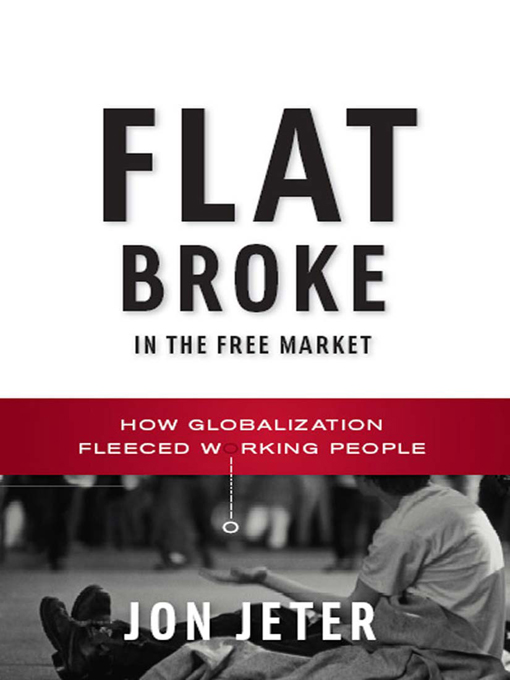
Flat Broke in the Free Market A powerful, accessible, and eye-opening analysis of the global economy. Growing up in an African American working-class family in the Midwest, Jon Jeter watched the jobs undergirding a community disappear. As a journalist for the Washington Post (twice a Pulitzer Prize finalist), he reported on the freemarket reforms of the IMF and the World Bank, which in a single generation created a transnational underclass.Led by the United States, nations around the world stopped making things and starting buying them, imbibing a risky cocktail of deindustrialization, privatization, and anti-inflationary monetary policy. Jeter gives the consequences of abstract economic policies a human face, and shows how our chickens are coming home to roost in the form of the subprime mortgage scandal, the food crisis, and the fraying of traditional social bonds (marriage). From Rio de Janeiro to Shanghai to Soweto to Chicago’s South Side and Washington, DC, Jeter shows us how the economic prescriptions of “the Washington Consensus†have only deepened poverty—while countries like Chile and Venezuela have flouted the conventional wisdom and prospered. POLITICAL SCIENCE,Globalization
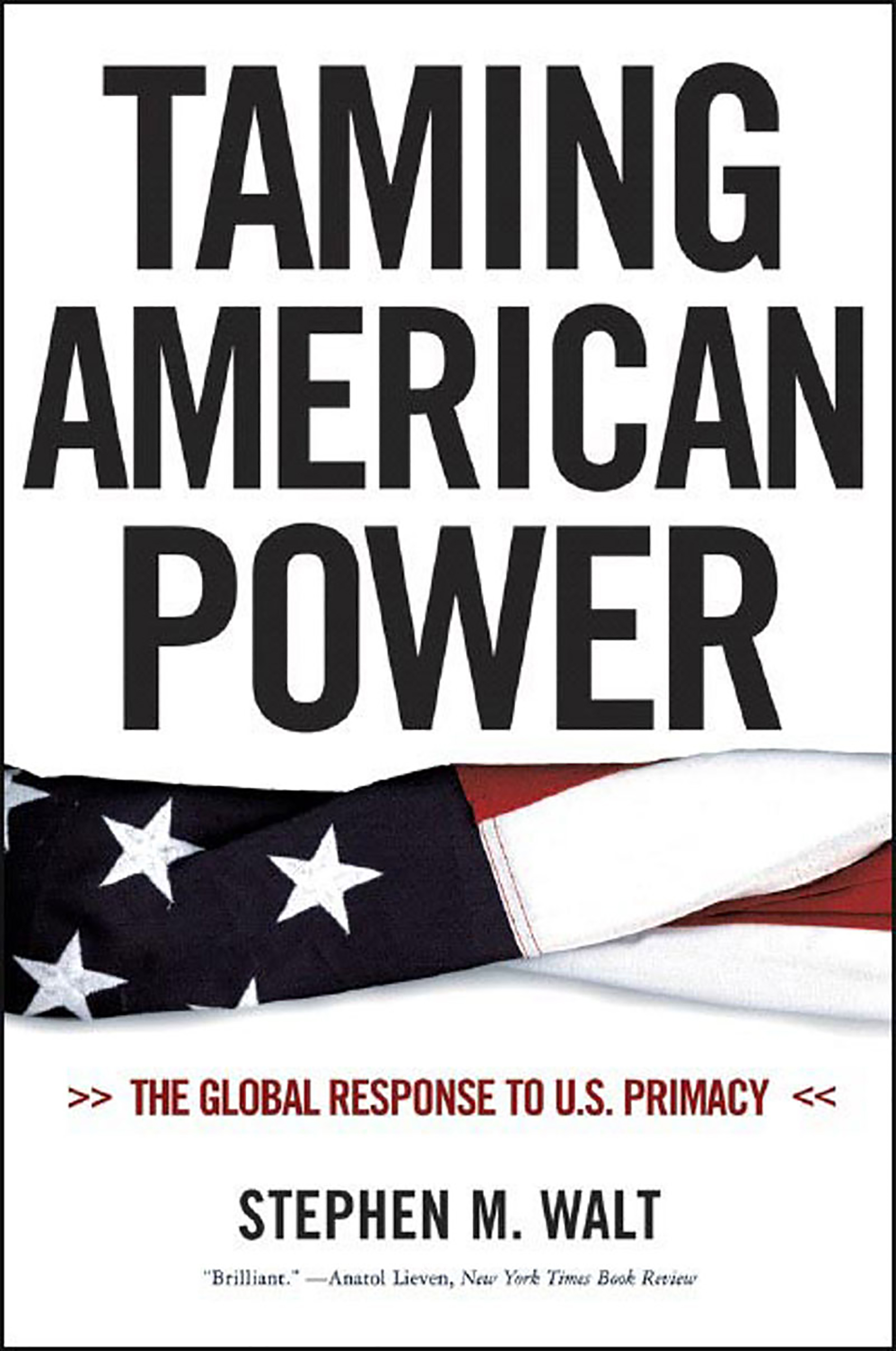
Taming American Power Finalist for the 2006 Gelber Prize: "A brilliant contribution to the American foreign policy debate."—Anatol Lieven, New York Times Book Review At a time when America's dominance abroad was being tested like never before, Taming American Power provided for the first time a "rigorous critique of current U.S. strategy" (Washington Post Book World) from the vantage point of its fiercest opponents. Stephen M. Walt examines America's place as the world's singular superpower and the strategies that rival states have devised to counter it. Hailed as a "landmark book" by Foreign Affairs, Taming American Power makes the case that this ever-increasing tide of opposition not only could threaten America's ability to achieve its foreign policy goals today but also may undermine its dominant position in years to come. POLITICAL SCIENCE,Globalization
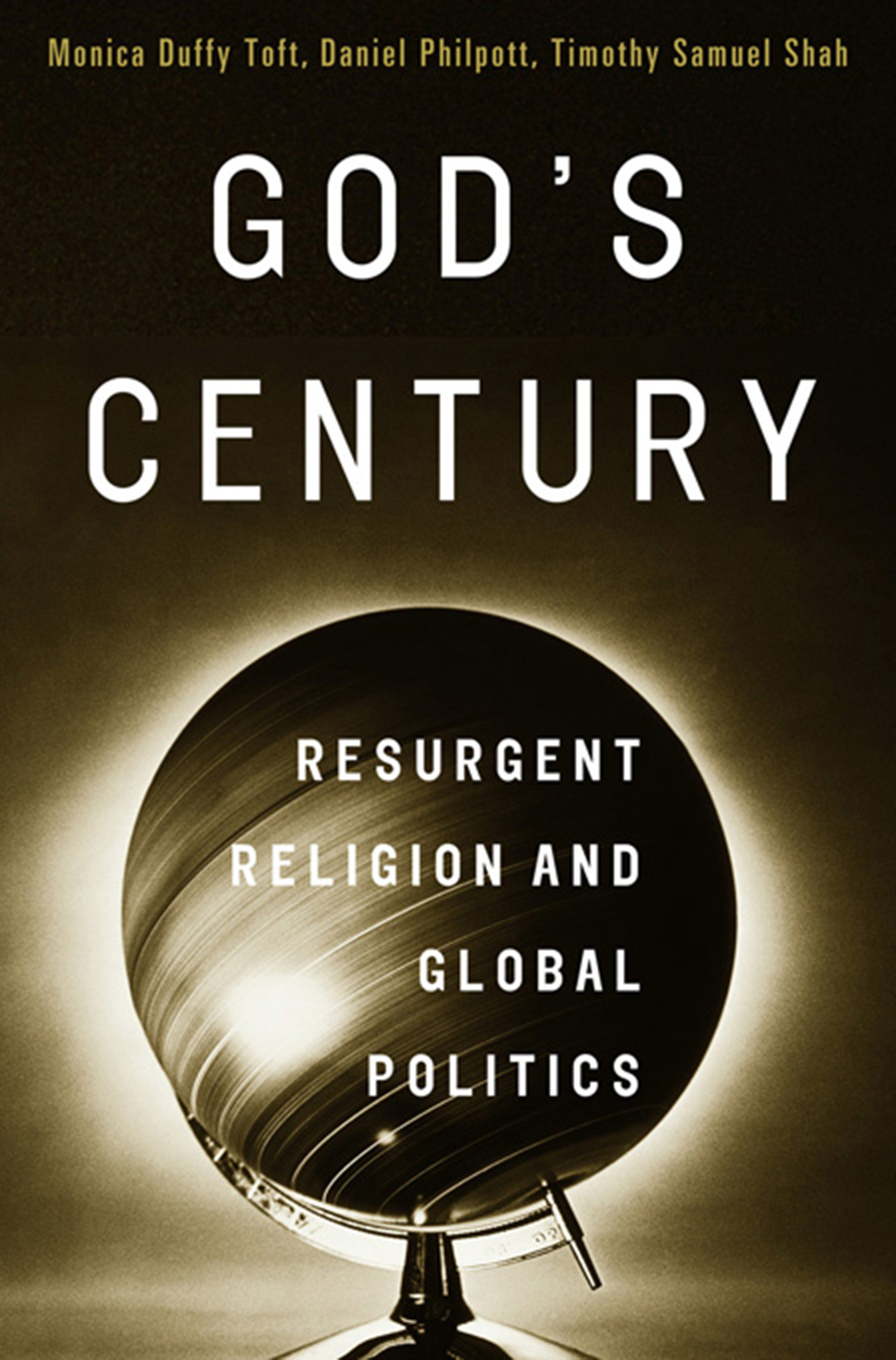
God's Century A fresh and illuminating perspective on the surge in religion’s political influence across the globe. Is religion a force for good or evil in world politics? How much influence does it have? Despite predictions of its decline, religion has resurged in political influence across the globe, helped by the very forces that were supposed to bury it: democracy, globalization, and technology. And despite recent claims that religion is exclusively irrational and violent, its political influence is in fact diverse, sometimes promoting civil war and terrorism but at other times fostering democracy, reconciliation, and peace. Looking across the globe, the authors explain what generates these radically divergent behaviors. In a time when the public discussion of religion is overheated, these dynamic young scholars use deeply original analysis and sharp case studies to show us both how and why religion’s influence on global politics is surging. Finally they offer concrete suggestions on how to both confront the challenges and take advantage of the opportunities posed by globally resurgent religion. POLITICAL SCIENCE,Globalization
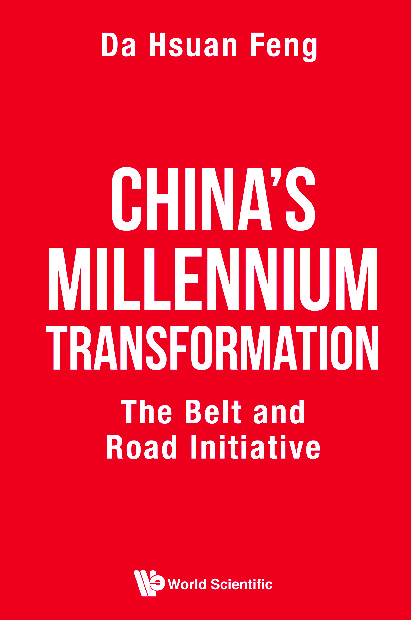
China's Millennium Transformation This is a book on the Belt and Road Initiative, written from an unusual perspective — it is written by someone who was born in India but raised in Singapore; who has never spent a day of schooling in the greater China (Mainland, Taiwan, Hong Kong and Macau) but has Chinese heritage; who eventually built a long and distinguished career in the West. With such an atypical background, he took an off-the-beaten-path approach by asking the fundamental question of how such an important initiative, began entirely by China, can deeply impact and transform the millennium mindset of Chinese.Such a transformation of the Chinese shall render a new definition of what a 'powerful nation' in the 21st century should be, for the betterment of humanity. This is unlike the one made by Western civilization for many centuries since the Renaissance days. Three main outcomes of the BRI have been embedded directly or indirectly throughout the book: Supercontinent, Neo-Renaissance and Cultural Communications. The author felt that these three outcomes are the possible mitigation for the world in the 21st century, facing existential challenges.Related Link(s) POLITICAL SCIENCE,Globalization

What's Wrong with Democracy? Fifth-century Athens is praised as the cradle of democracy and sometimes treated as a potential model for modern political theory or practice. In this daring reassessment of classical Athenian democracy and its significance for the United States today, Loren J. Samons provides ample justification for our founding fathers' distrust of democracy, a form of government they scorned precisely because of their familiarity with classical Athens. How Americans have come to embrace "democracy" in its modern form—and what the positive and negative effects have been—is an important story for all contemporary citizens. Confronting head-on many of the beliefs we hold dear but seldom question, Samons examines Athens's history in the fifth and fourth centuries B.C. in order to test the popular idea that majority rule leads to good government. Challenging many basic assumptions about the character and success of Athenian democracy, What's Wrong with Democracy? offers fascinating and accessible discussions of topics including the dangers of the popular vote, Athens's acquisitive foreign policy, the tendency of the state to overspend, the place of religion in Athenian society, and more. Sure to generate controversy, Samons's bold and iconoclastic book finds that democracy has begun to function like an unacknowledged religion in our culture, immune from criticism and dissent, and he asks that we remember the Athenian example and begin to question our uncritical worship of democratic values such as freedom, choice, and diversity. POLITICAL SCIENCE,History & Theory
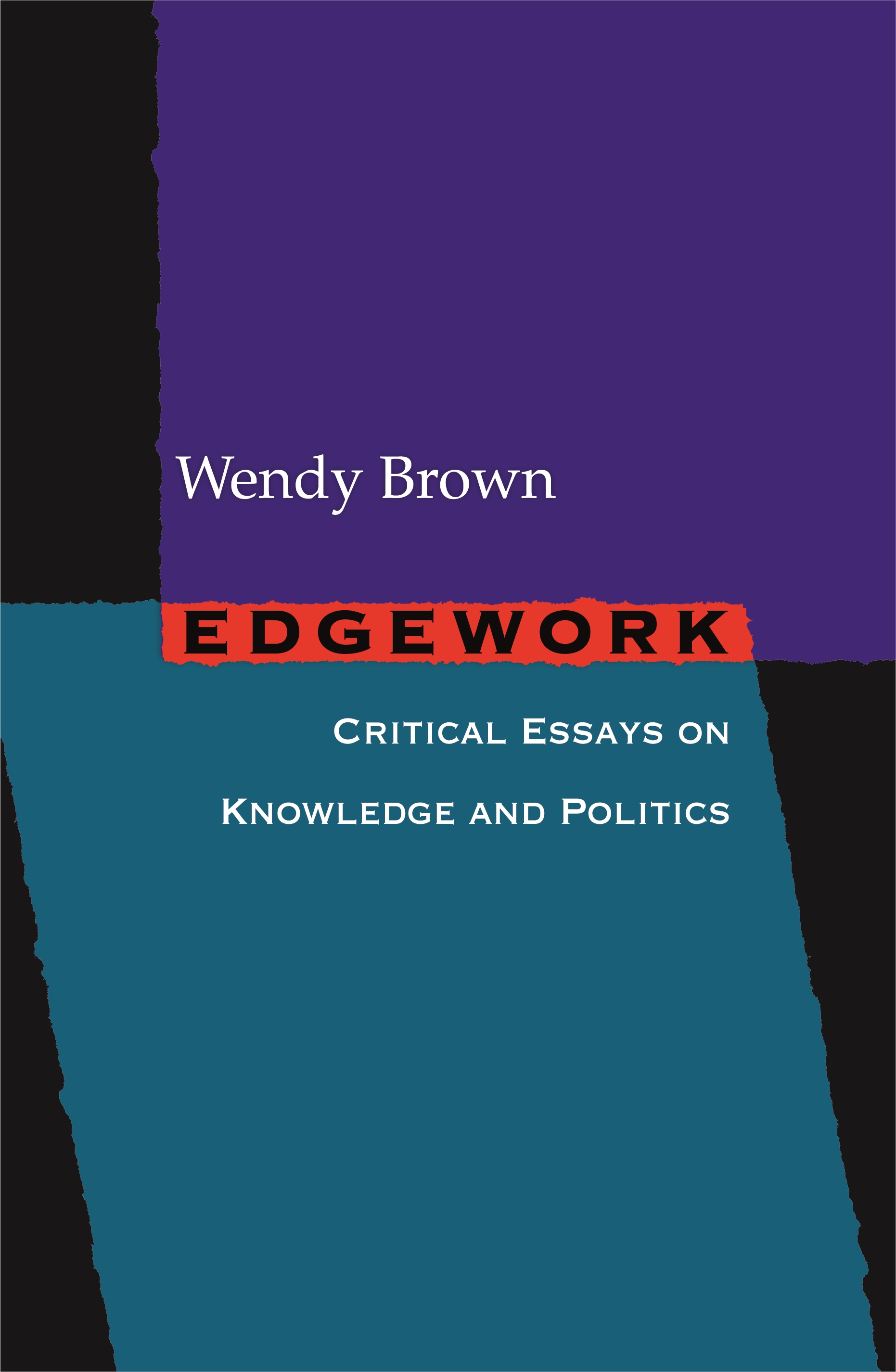
Edgework Edgework brings together seven of Wendy Brown's most provocative recent essays in political and cultural theory. They range from explorations of politics post-9/11 to critical reflections on the academic norms governing feminist studies and political theory. Edgework is also concerned with the intellectual and political value of critique itself. It renders contemporary the ancient jurisprudential meaning of critique as krisis, in which a tear in the fabric of justice becomes the occasion of a public sifting or thoughtfulness, the development of criteria for judgment, and the inauguration of political renewal or restoration. Each essay probes a contemporary problem--the charge of being unpatriotic for dissenting from U.S. foreign policy, the erosion of liberal democracy by neoliberal political rationality, feminism's loss of a revolutionary horizon--and seeks to grasp the intellectual impasse the problem signals as well as the political incitement it may harbor. POLITICAL SCIENCE,History & Theory
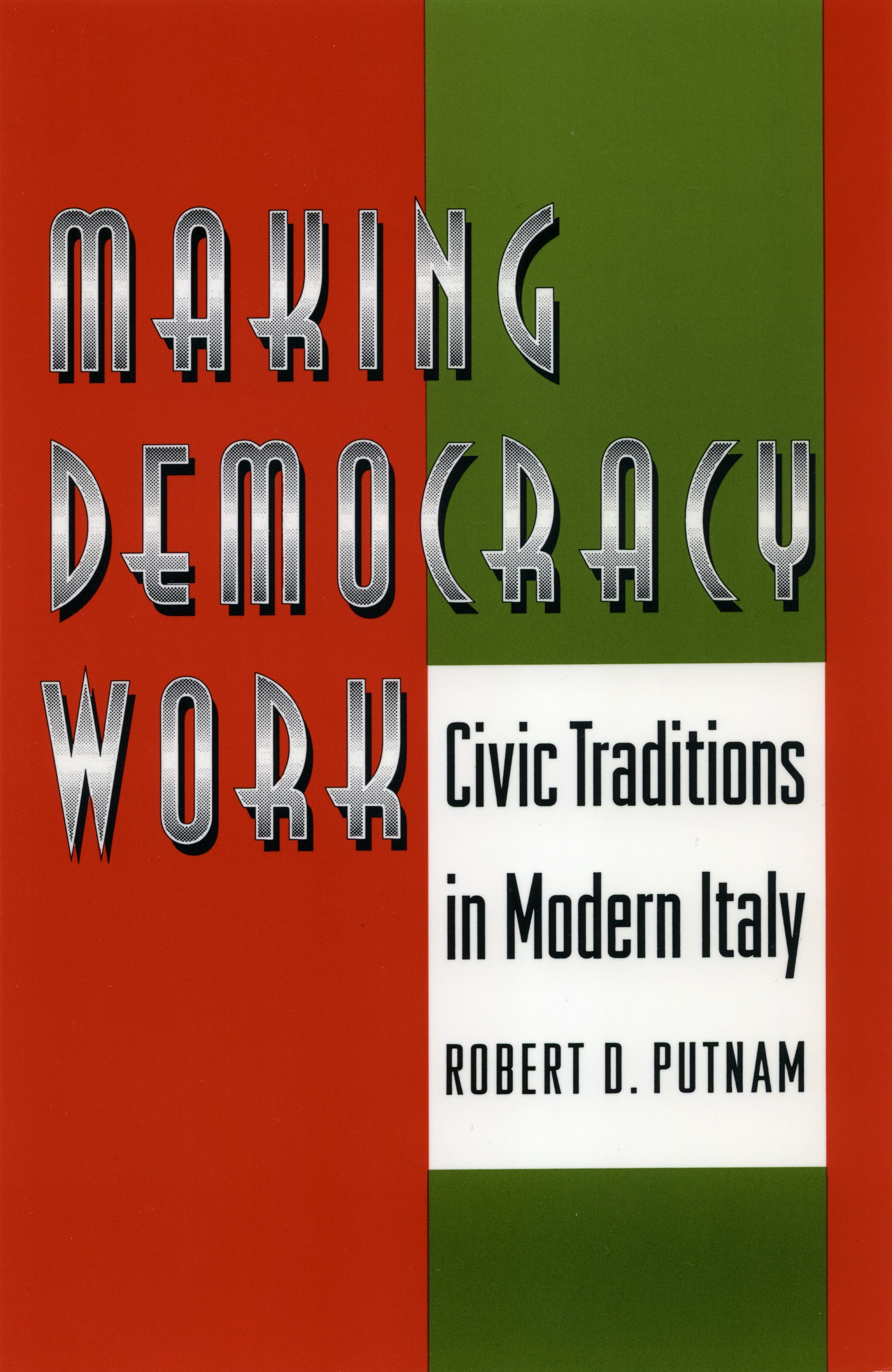
Making Democracy Work Why do some democratic governments succeed and others fail? In a book that has received attention from policymakers and civic activists in America and around the world, Robert Putnam and his collaborators offer empirical evidence for the importance of "civic community" in developing successful institutions. Their focus is on a unique experiment begun in 1970 when Italy created new governments for each of its regions. After spending two decades analyzing the efficacy of these governments in such fields as agriculture, housing, and health services, they reveal patterns of associationism, trust, and cooperation that facilitate good governance and economic prosperity. POLITICAL SCIENCE,History & Theory

Understanding Institutional Diversity The analysis of how institutions are formed, how they operate and change, and how they influence behavior in society has become a major subject of inquiry in politics, sociology, and economics. A leader in applying game theory to the understanding of institutional analysis, Elinor Ostrom provides in this book a coherent method for undertaking the analysis of diverse economic, political, and social institutions. Understanding Institutional Diversity explains the Institutional Analysis and Development (IAD) framework, which enables a scholar to choose the most relevant level of interaction for a particular question. This framework examines the arena within which interactions occur, the rules employed by participants to order relationships, the attributes of a biophysical world that structures and is structured by interactions, and the attributes of a community in which a particular arena is placed. The book explains and illustrates how to use the IAD in the context of both field and experimental studies. Concentrating primarily on the rules aspect of the IAD framework, it provides empirical evidence about the diversity of rules, the calculation process used by participants in changing rules, and the design principles that characterize robust, self-organized resource governance institutions. POLITICAL SCIENCE,History & Theory
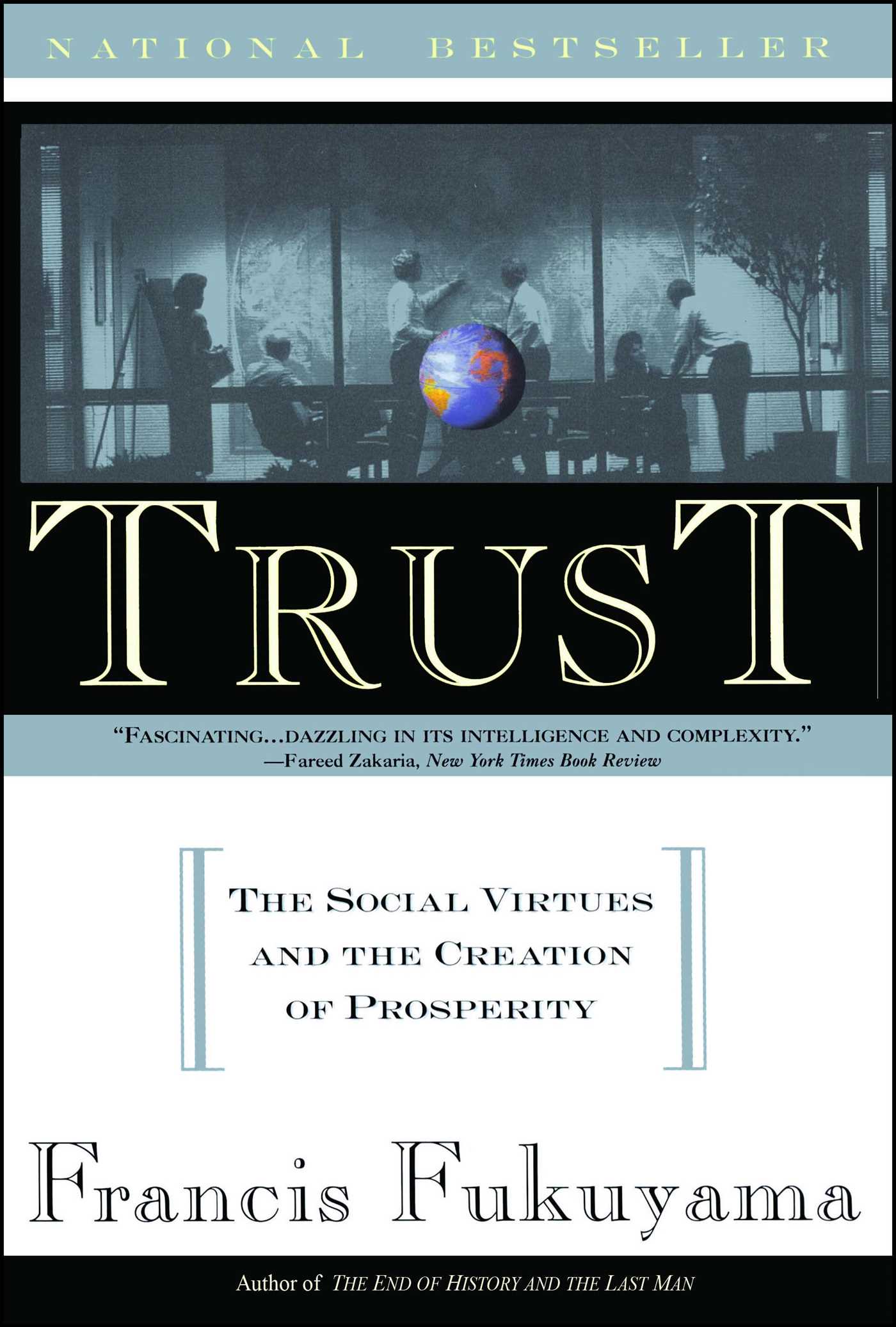
Trust In his bestselling The End of History and the Last Man, Francis Fukuyama argued that the end of the Cold War would also mean the beginning of a struggle for position in the rapidly emerging order of 21st-century capitalism. In Trust, a penetrating assessment of the emerging global economic order "after History," he explains the social principles of economic life and tells us what we need to know to win the coming struggle for world dominance. Challenging orthodoxies of both the left and right, Fukuyama examines a wide range of national cultures in order to divine the underlying principles that foster social and economic prosperity. Insisting that we cannot divorce economic life from cultural life, he contends that in an era when social capital may be as important as physical capital, only those societies with a high degree of social trust will be able to create the flexible, large-scale business organizations that are needed to compete in the new global economy. A brilliant study of the interconnectedness of economic life with cultural life, Trust is also an essential antidote to the increasing drift of American culture into extreme forms of individualism, which, if unchecked, will have dire consequences for the nation's economic health. POLITICAL SCIENCE,History & Theory

Analyzing the Global Political Economy Ideally suited to upper-undergraduate and graduate students, Analyzing the Global Political Economy critically assesses the convergence between IPE, comparative political economy, and economics. Andrew Walter and Gautam Sen show that a careful engagement with economics is essential for understanding both contemporary IPE and for analyzing the global political economy. The authors also argue that the deployment of more advanced economic theories should not detract from the continuing importance for IPE of key concepts from political science and international relations. IPE students with little or no background in economics will therefore find this book useful, and economics students interested in political economy will be alerted to the comparative strengths of political science and other social science disciplines. A concise look at the foundations of analysis in the political economy of global trade, money, finance, and investment Suitable for upper-undergraduate and graduate students with some or no economic background Techniques and findings from a range of academic disciplines, including international relations, political science, economics, sociology, and history Further reading and useful weblinks including a range of relevant data sources, listed in each chapter POLITICAL SCIENCE,History & Theory
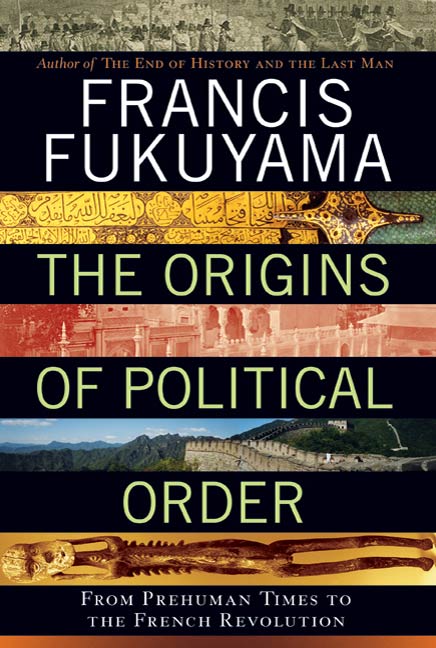
The Origins of Political Order A New York Times Notable Book for 2011 A Globe and Mail Best Books of the Year 2011 TitleA Kirkus Reviews Best Nonfiction of 2011 title Virtually all human societies were once organized tribally, yet over time most developed new political institutions which included a central state that could keep the peace and uniform laws that applied to all citizens. Some went on to create governments that were accountable to their constituents. We take these institutions for granted, but they are absent or are unable to perform in many of today's developing countries—with often disastrous consequences for the rest of the world. Francis Fukuyama, author of the bestselling The End of History and the Last Man and one of our most important political thinkers, provides a sweeping account of how today's basic political institutions developed. The first of a major two-volume work, The Origins of Political Order begins with politics among our primate ancestors and follows the story through the emergence of tribal societies, the growth of the first modern state in China, the beginning of the rule of law in India and the Middle East, and the development of political accountability in Europe up until the eve of the French Revolution. Drawing on a vast body of knowledge—history, evolutionary biology, archaeology, and economics—Fukuyama has produced a brilliant, provocative work that offers fresh insights on the origins of democratic societies and raises essential questions about the nature of politics and its discontents. POLITICAL SCIENCE,History & Theory

Diversity and Complexity This book provides an introduction to the role of diversity in complex adaptive systems. A complex system--such as an economy or a tropical ecosystem--consists of interacting adaptive entities that produce dynamic patterns and structures. Diversity plays a different role in a complex system than it does in an equilibrium system, where it often merely produces variation around the mean for performance measures. In complex adaptive systems, diversity makes fundamental contributions to system performance. Scott Page gives a concise primer on how diversity happens, how it is maintained, and how it affects complex systems. He explains how diversity underpins system level robustness, allowing for multiple responses to external shocks and internal adaptations; how it provides the seeds for large events by creating outliers that fuel tipping points; and how it drives novelty and innovation. Page looks at the different kinds of diversity--variations within and across types, and distinct community compositions and interaction structures--and covers the evolution of diversity within complex systems and the factors that determine the amount of maintained diversity within a system. Provides a concise and accessible introduction Shows how diversity underpins robustness and fuels tipping points Covers all types of diversity The essential primer on diversity in complex adaptive systems POLITICAL SCIENCE,History & Theory
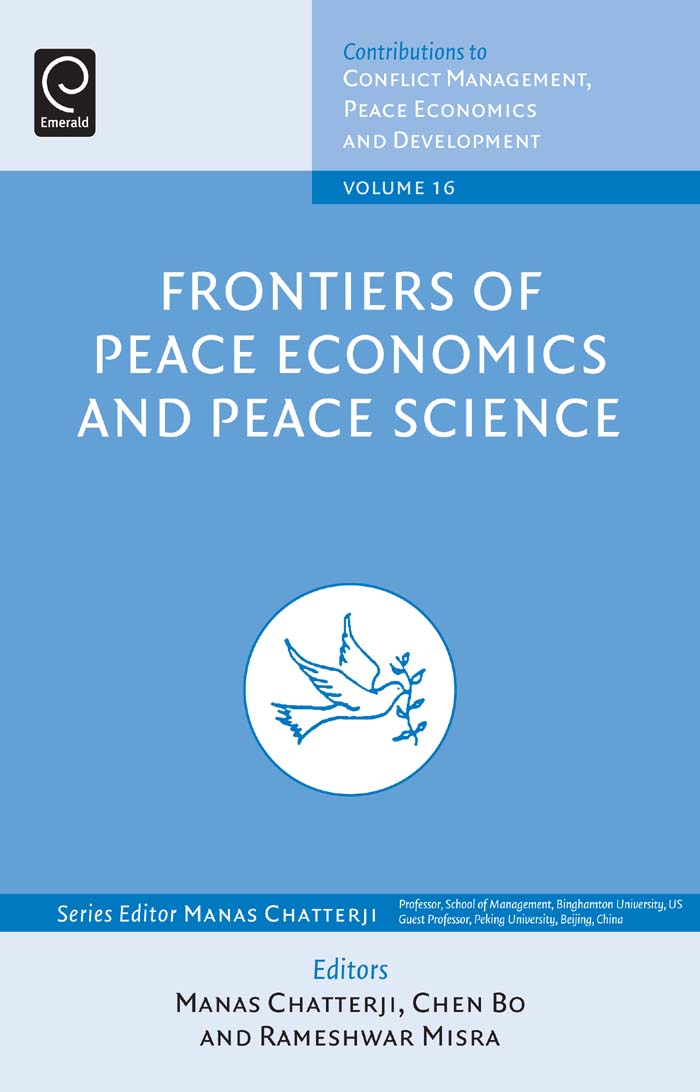
Frontiers of Peace Economics and Peace Science A considerable amount of work has been conducted in the field of peace studies, conflict management, peace science in economics, sociology, anthropology and management. This title presents research with an emphasis on theoretical and mathematical constructs in the area of peace economics & peace science. POLITICAL SCIENCE,History & Theory

Capital 'A groundbreaking work of economic analysis. It is also a literary masterpice' Francis Wheen, Guardian One of the most notorious and influential works of modern times, Capital is an incisive critique of private property and the social relations it generates. Living in exile in England, where this work was largely written, Marx drew on a wide-ranging knowledge of its society to support his analysis. Arguing that capitalism would cause an ever-increasing division in wealth and welfare, he predicted its abolition and replacement by a system with common ownership of the means of production. Capital rapidly acquired readership throughout the world, to become a work described by Marx's collaborator Friedrich Engels as 'the Bible of the working class'. Translated by BEN FOWKES with an Introduction by ERNEST MANDEL POLITICAL SCIENCE,History & Theory

Leviathan The Leviathan is the vast unity of the State. But how are unity, peace and security to be attained? Hobbes's answer is sovereignty, but the resurgence of interest today in Leviathan is due less to its answers than its methods. Hobbes sees politics as a science capable of the same axiomatic approach as geometry: he argues from first principles to human nature to politics. This book's appeal to the twentieth century lies not just in its elevation of politics to a science, but in its overriding concern for peace. POLITICAL SCIENCE,History & Theory
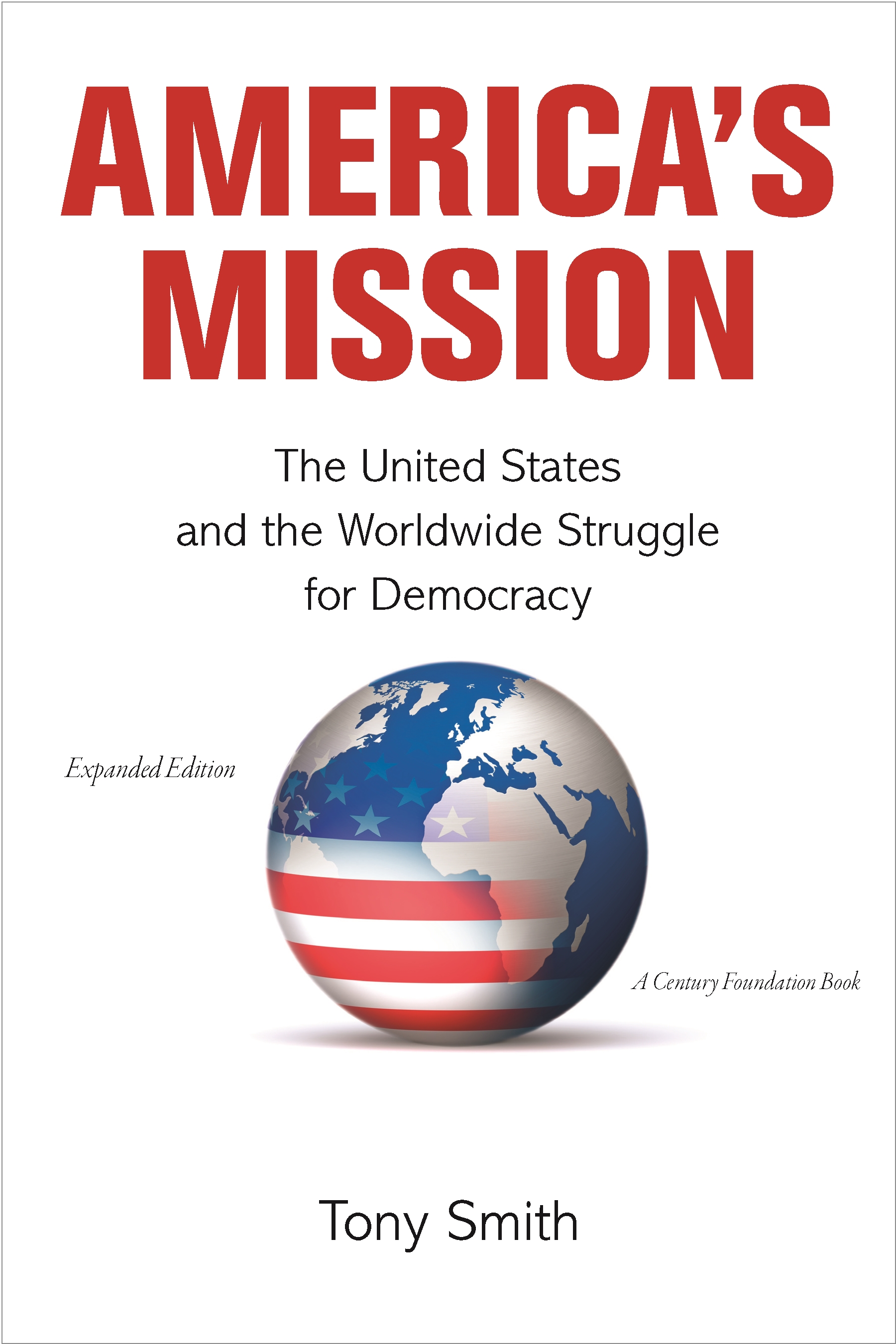
America's Mission America's Mission argues that the global strength and prestige of democracy today are due in large part to America's impact on international affairs. Tony Smith documents the extraordinary history of how American foreign policy has been used to try to promote democracy worldwide, an effort that enjoyed its greatest triumphs in the occupations of Japan and Germany but suffered huge setbacks in Latin America, Vietnam, and elsewhere. With new chapters and a new introduction and epilogue, this expanded edition also traces U.S. attempts to spread democracy more recently, under presidents Clinton, Bush, and Obama, and assesses America's role in the Arab Spring. POLITICAL SCIENCE,History & Theory

If Kennedy Lived What if Kennedy were not killed that fateful day? What would the 1964 campaign have looked like? Would changes have been made to the ticket? How would Kennedy, in his second term, have approached Vietnam, civil rights, the Cold War? With Hoover as an enemy, would his indiscreet private life finally have become public? Would his health issues have become so severe as to literally cripple his presidency? And what small turns of fate in the days and years before Dallas might have kept him from ever reaching the White House in the first place? The answers Greenfield provides and the scenarios he develops are startlingly realistic, rich in detail, shocking in their projections, but always deeply, remarkably plausible. If Kennedy Lived is a tour de force of American history from one of the country’s most brilliant and illuminating political commentators. POLITICAL SCIENCE,History & Theory
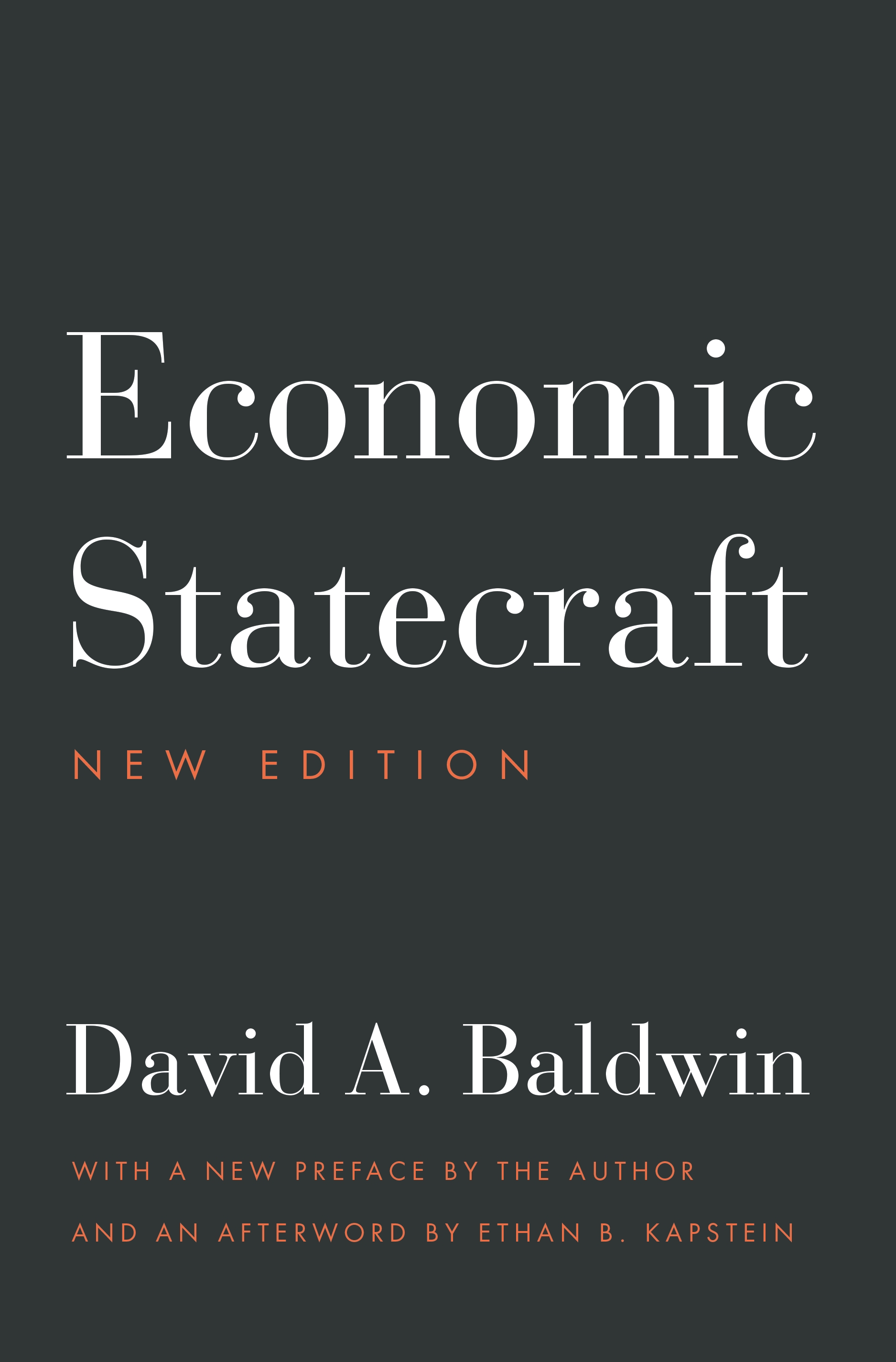
Economic Statecraft A new edition of the classic work on the economic tools of foreign policy Today's complex and dangerous world demands a complete understanding of all the techniques of statecraft, not just military ones. David Baldwin's Economic Statecraft presents an analytic framework for evaluating such techniques and uses it to challenge the notion that economic instruments of foreign policy do not work. Integrating insights from economics, political science, psychology, philosophy, history, law, and sociology, this bold and provocative book explains not only the utility of economic statecraft but also its morality, legality, and role in the history of international thought. Economic Statecraft is a landmark work that has fundamentally redefined how nations evaluate crucial choices of war and peace. Now with a substantial new preface by the author and an afterword by esteemed foreign-policy expert Ethan Kapstein, this new edition introduces today's generation of readers to the principles and applications of economic statecraft. POLITICAL SCIENCE,History & Theory

Stories, Identities, and Political Change This book tackles fundamental questions about the nature of personal, political, and national identities and their linkage to big events_revolutions, social movements, democratization, and other processes of political and social change. Tilly focuses on the role of stories, as means of creating personal identity, but also as explanations, true or false, of political tensions and realities. He writes with the immediacy of a journalist, but the profound insight of a great theorist. POLITICAL SCIENCE,History & Theory

The Politics Book The Politics Book clearly and simply explains more than one hundred groundbreaking ideas in the history of political thought. Using easy-to-follow graphics and artworks, succinct quotations, and thoroughly accessible text, The Politics Book elucidates the theoretical foundations-as well as the practical applications-of political thought, making abstract concepts concrete. The Politics Book includes innovative ideas from ancient and medieval philosophers ranging from Confucius and Thomas Aquinas to revolutionary thought leaders such as Thomas Jefferson and Leon Trotsky. The voices that have shaped modern politics today, from Mao Zedong to Malcolm X, are also included, giving anyone with an interest in politics an essential resource to political thinking and policy. The Politics Book includes: - Key ideas from more than one hundred of the great politicians and political thinkers from antiquity to present day - Biographies and context boxes to give the full historical context of each idea - A reference section with a glossary of political terms and a directory of political thinkers The clear and concise summaries, graphics, and quotations in The Politics Book will help even the complete novice understand the fascinating world of political thought. POLITICAL SCIENCE,History & Theory
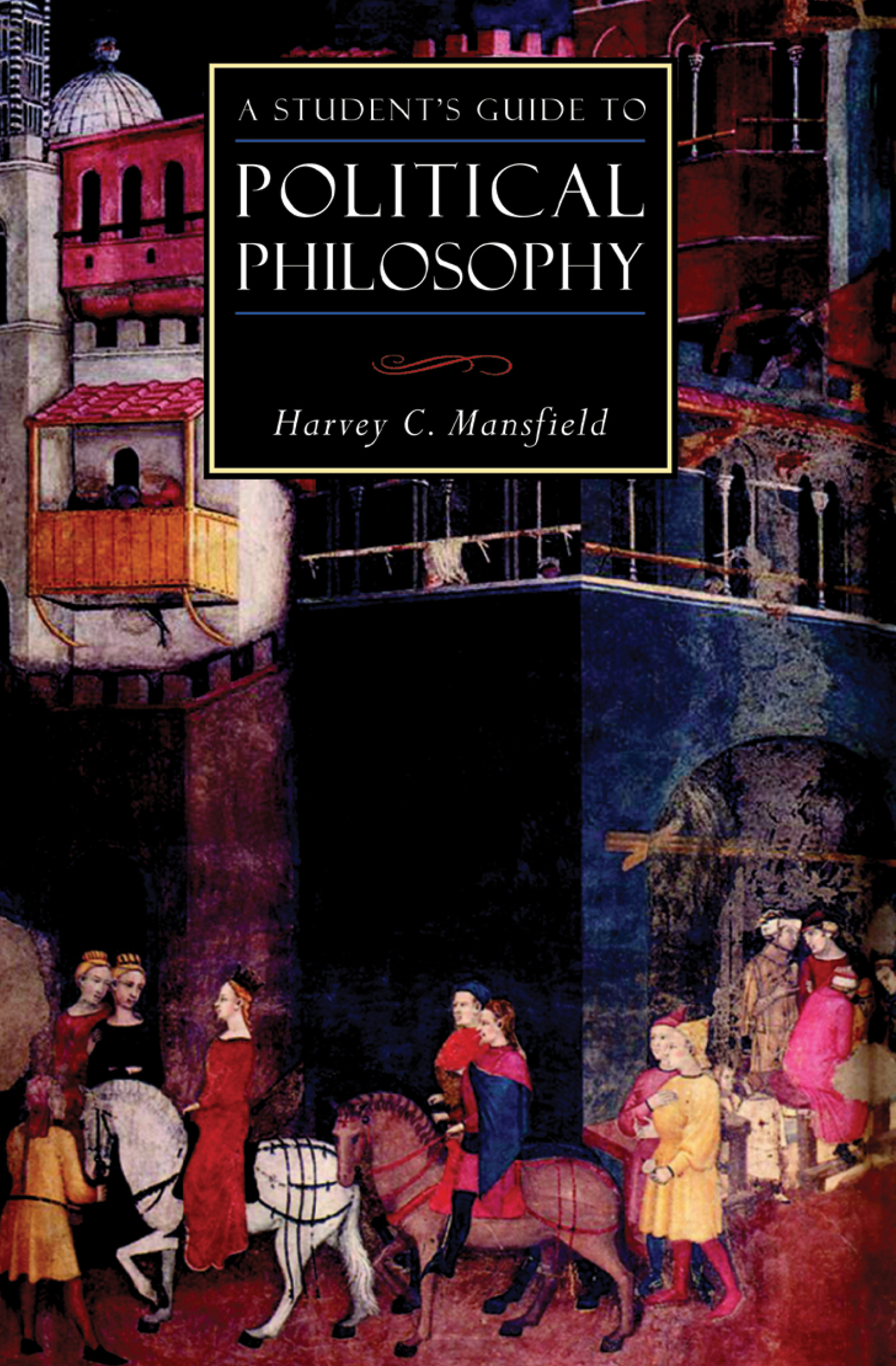
A Student's Guide to Political Philosophy A primer on the bedrock principles of politics from “Harvard’s most controversial conservative professor†and the author of Democracy in America (Boston magazine). Behind the daily headlines on presidential races and local elections is the theory of the polity—or what the end of our politics should be. Harvard’s Harvey C. Mansfield, one of America’s leading political theorists, explains why our quest for the good life must address the type of government we seek to uphold. He directs our gaze to the thinkers and philosophies and classic works that have proved most influential throughout the ages. POLITICAL SCIENCE,History & Theory

The Utopia of Rules From the author of the international bestseller Debt: The First 5,000 Years comes a revelatory account of the way bureaucracy rules our lives Where does the desire for endless rules, regulations, and bureaucracy come from? How did we come to spend so much of our time filling out forms? And is it really a cipher for state violence? To answer these questions, the anthropologist David Graeber—one of our most important and provocative thinkers—traces the peculiar and unexpected ways we relate to bureaucracy today, and reveals how it shapes our lives in ways we may not even notice…though he also suggests that there may be something perversely appealing—even romantic—about bureaucracy. Leaping from the ascendance of right-wing economics to the hidden meanings behind Sherlock Holmes and Batman, The Utopia of Rules is at once a powerful work of social theory in the tradition of Foucault and Marx, and an entertaining reckoning with popular culture that calls to mind Slavoj Zizek at his most accessible. An essential book for our times, The Utopia of Rules is sure to start a million conversations about the institutions that rule over us—and the better, freer world we should, perhaps, begin to imagine for ourselves. POLITICAL SCIENCE,History & Theory

How to Run A Government Billions of citizens around the world are frustrated with their governments. Why is this? And what can we do about it? In this groundbreaking book Michael Barber draws on his wealth of international experience advising political leaders, to show how those in power can make good on their promises. 'Refreshingly ruthless ... has an uplifting brio to it' Economist 'Michael Barber is a source of inspiration and wisdom' Andrew Adonis, New Statesman 'Excellent ... there is a lot of common sense and practical wisdom ... a breath of fresh air' David Willetts,Standpoint 'Barber is the global overlord of public policy ... a record around the world of actually achieving change' Philip Collins, Prospect POLITICAL SCIENCE,History & Theory

The Politics of Motion Two principal issues interact and overlap in this penetrating analysis: the relationship between Hobbes' natural philosophy and his civil philosophy, and the relationship between Hobbes' thought and the Aristotelian world view that constituted the philosophical orthodoxy he rejected. On the first point Thomas A. Spragens Jr. argues that Hobbes' political ideas were in fact significantly influenced by his cosmological perceptions, although they were not, and could not have been, completely derived from that source. On the second, the author demonstrates that Hobbes undertook a highly systematic transformation of Aristotelian cosmology: he borrowed the form of the Aristotelian cosmology, but radically refashioned its substance to accommodate the discoveries of contemporaries such as Galileo. POLITICAL SCIENCE,History & Theory
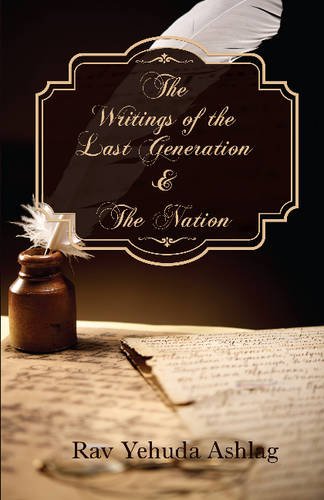
The Writings of the Last Generation In 1940, Rav Yehuda Ashlag published the first, and only copy of the paper, The Nation. After WWII, he wrote The Writings of the Last Generation. In them, he contemplates causes and solutions to anti-Semitism that make you wonder how history might have unfolded had we known about them earlier. POLITICAL SCIENCE,History & Theory

The Society of the Spectacle Few works of political and cultural theory have been as enduringly provocative as Guy Debord’s Society of the Spectacle. From its publication amid the social upheavals of the 1960s to the present, the volatile theses of this book have decisively transformed debates on the shape of modernity, capitalism, and everyday life in the late twentieth century. Now finally available in a superb English translation approved by the author, Debord’s text remains as crucial as ever for understanding the contemporary effects of power, which are increasingly inseparable from the new virtual worlds of our rapidly changing image / information culture. “In all that has happened in the last twenty years, the most important change lies in the very continuity of the spectacle. Quite simply, the spectacle’s domination has succeeded in raising a whole generation moulded to its laws. The extraordinary new conditions in which this entire generation has lived constitute a comprehensive summary of all that, henceforth, the spectacle will forbid; and also all that it will permit.â€â€” Guy Debord (1988) POLITICAL SCIENCE,History & Theory

Walled States, Waning Sovereignty Why, just two decades after international celebrations of the fall of the Berlin Wall, are so many nation-states building elaborate walls at or near their borders? Why walls now, given growing global connectedness and given the general imperviousness of late modern powers — from capital to religion to terror — to physical blockading? How do walls shore up an imago of sovereign statehood and to what extent do they fortify reactionary national imaginaries? What do the new walls perform symbolically, materially, psychically? In Walled States, Waning Sovereignty, Wendy Brown reflects on the proliferation of nation-state walls in a time of eroded nation-state sovereignty and intensifying transnational powers unleashed by globalization. A leading theorist of neoliberalism, Brown argues that although the new walls may demarcate existent or aspirational nation-state boundaries, they do not arise as fortresses against invading national armies or even as articulations of sovereign statehood. Rather, in a post-Westphalian context of increasing nonstate transnational actors and powers, the new walls consecrate the very boundary corruption they would contest as well as signify the contemporary limitations of national and global governance by law or political dictate. Even as walls theatrically display nation-state sovereignty, they index with equal force the decline of sovereign state power. In a rare combination of powerful theory and precise historical, political, and economic analysis, Walled States, Waning Sovereignty provides a new — indeed the first — account of nation-state walling as a distinctive contemporary phenomenon. For Brown, the frenzy of wall building today reveals crucial predicaments of political power and desire emerging from the waning of sovereignty, including new political legitimacy deficits, new citizen anxieties, and new fusions of state and non-state violence. POLITICAL SCIENCE,History & Theory

Post-Western World With the United States' superpower status rivalled by a rising China and emerging powers like India and Brazil playing a growing role in international affairs, the global balance of power is shifting. But what does this mean for the future of the international order? Will China dominate the 21st Century? Will the so-called BRICS prove to be a disruptive force in global affairs? Are we headed towards a world marked by frequent strife, or will the end of Western dominance make the world more peaceful? In this provocative new book, Oliver Stuenkel argues that our understanding of global order and predictions about its future are limited because we seek to imagine the post-Western world from a parochial Western-centric perspective. Such a view is increasingly inadequate in a world where a billions of people regard Western rule as a temporary aberration, and the rise of Asia as a return to normalcy. In reality, China and other rising powers that elude the simplistic extremes of either confronting or joining existing order are quietly building a "parallel order" which complements today's international institutions and increases rising powers' autonomy. Combining accessibility with expert sensitivity to the complexities of the global shift of power, Stuenkel's vision of a post-Western world will be core reading for students and scholars of contemporary international affairs, as well as anyone interested in the future of global politics. "A fascinating interpretation of our understanding of politics and global affairs, which demonstrates the evolving nature of power today. Oliver Stuenkel presents a compelling argument - not just about the "Rise of the Rest", but also the overlooked power and influence of the non-Western world. Highly engaging and instructive." Dr Shashi Tharoor, India’s Minister of State for External Affairs (2009-10) "Oliver Stuenkel is one of the best new voices in the field of international politics. In Post-Western World, he explores the primary challenges of the global order and critiques the parochial, Eurocentric vision which conforms to international power structures. This book is essential reading for anyone seeking to understand what a multipolar world order would look like and how it might be effectively realized." Celso Amorim, Brazil’s Minister of External Relations (1993-5, 2003-11) and Minister of Defence (2011-15) POLITICAL SCIENCE,History & Theory
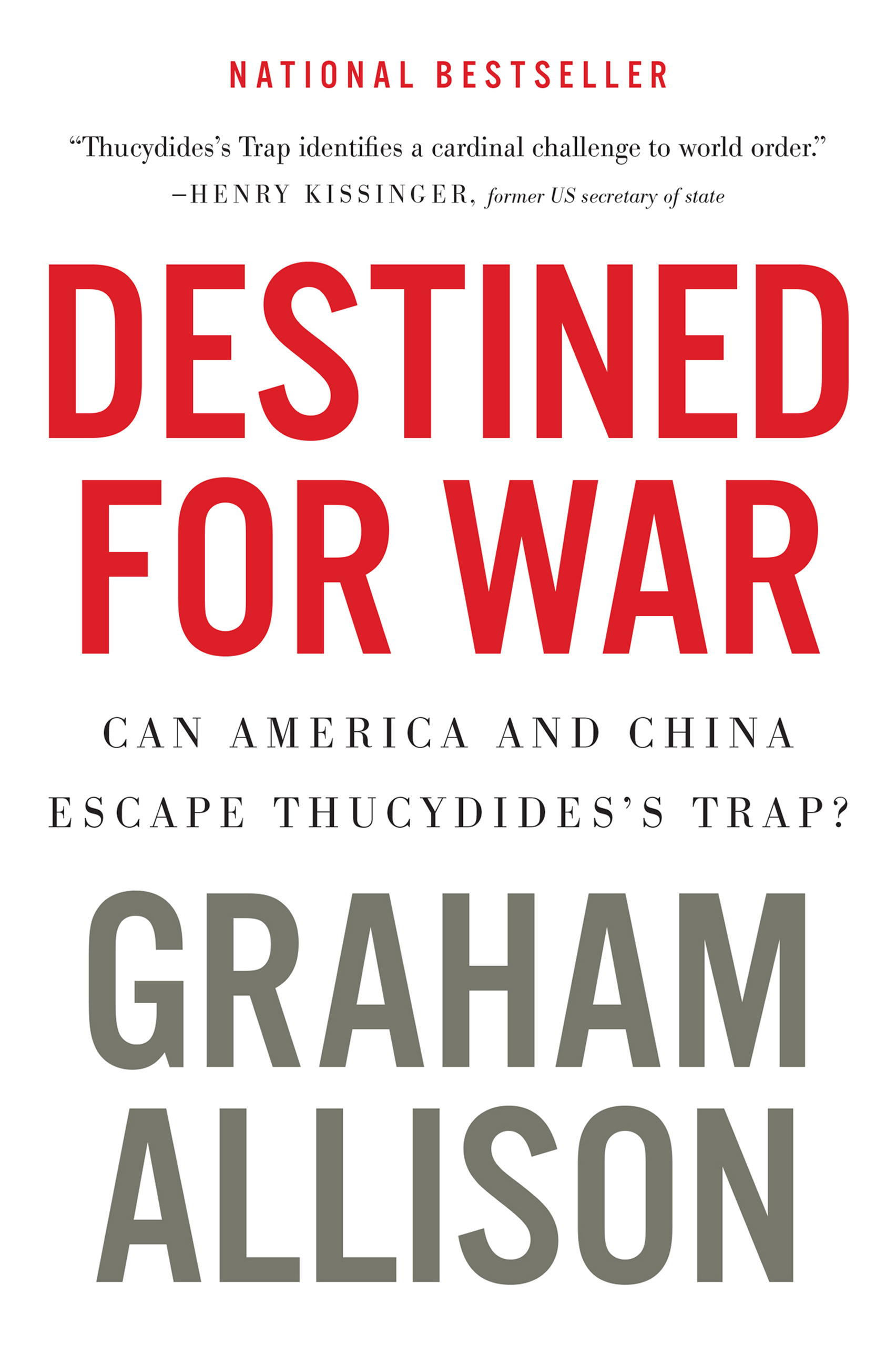
Destined for War From an eminent international security scholar, an urgent examination of the conditions that could produce a catastrophic conflict between the United States and China—and how it might be prevented POLITICAL SCIENCE,History & Theory
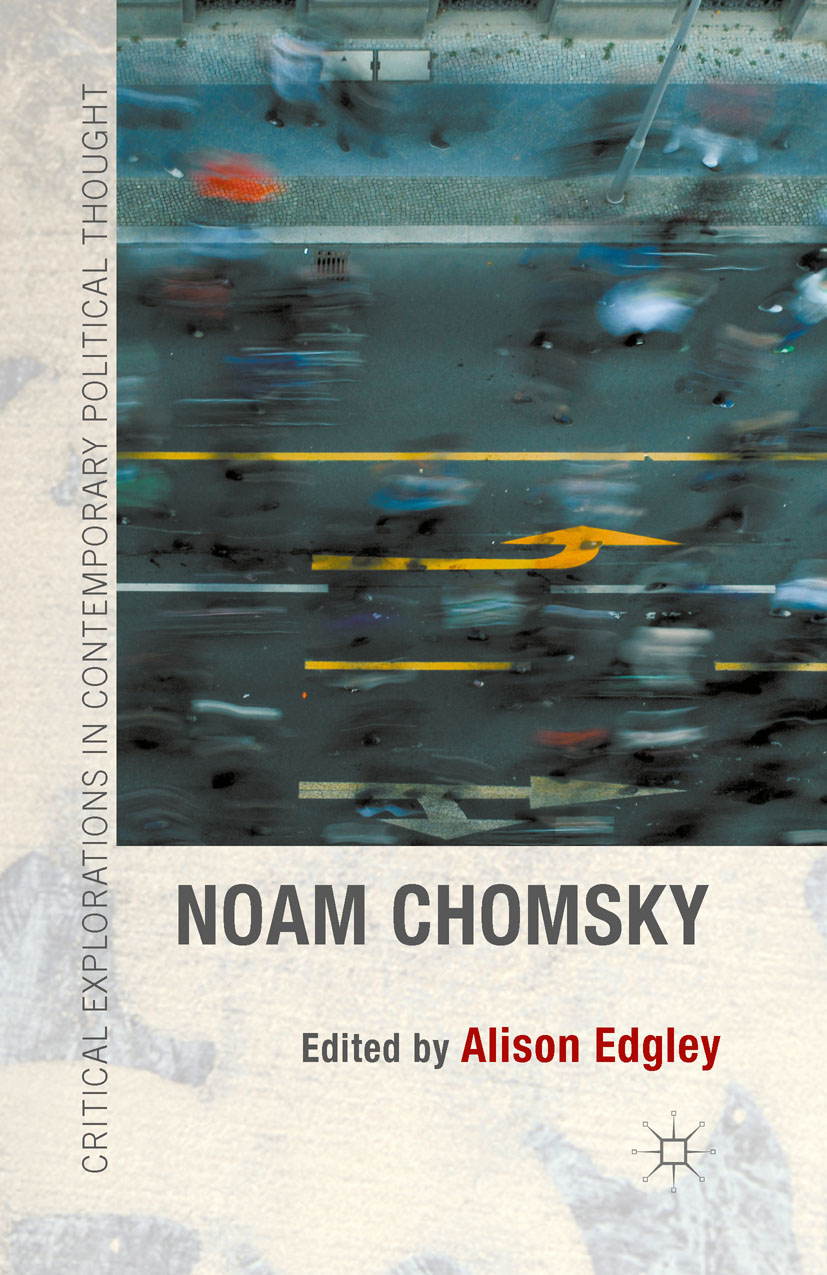
Noam Chomsky Exploring the key debates surrounding human nature, epistemology, the nature of social knowledge, foreign policy, the Propaganda Model, the anarchist tradition and the revolutionary transformation of society, this book reveals and explains the structure and power of Chomsky's work. POLITICAL SCIENCE,History & Theory

Virtue and Terror Robespierre’s justification of the Terror in the French Revolution Robespierre’s defence of the French Revolution remains one of the most powerful and unnerving justifications for political violence ever written. It has an extraordinary resonance in a world obsessed with terrorism and appalled by the language of its proponents. Yet today the French Revolution is celebrated as the event which gave birth to a nation built on the principles of Enlightenment. So how should a contemporary audience approach Robespierre’s vindication of revolutionary terror? Žižek’s introduction analyzes these contradictions with a prodigious breadth of analogy and reference. POLITICAL SCIENCE,History & Theory

Psychopolitics Exploring how neoliberalism has discovered the productive force of the psyche Byung-Chul Han, a star of German philosophy, continues his passionate critique of neoliberalism, trenchantly describing a regime of technological domination that, in contrast to Foucault’s biopower, has discovered the productive force of the psyche. In the course of discussing all the facets of neoliberal psychopolitics fueling our contemporary crisis of freedom, Han elaborates an analytical framework that provides an original theory of Big Data and a lucid phenomenology of emotion. But this provocative essay proposes counter models too, presenting a wealth of ideas and surprising alternatives at every turn. POLITICAL SCIENCE,History & Theory
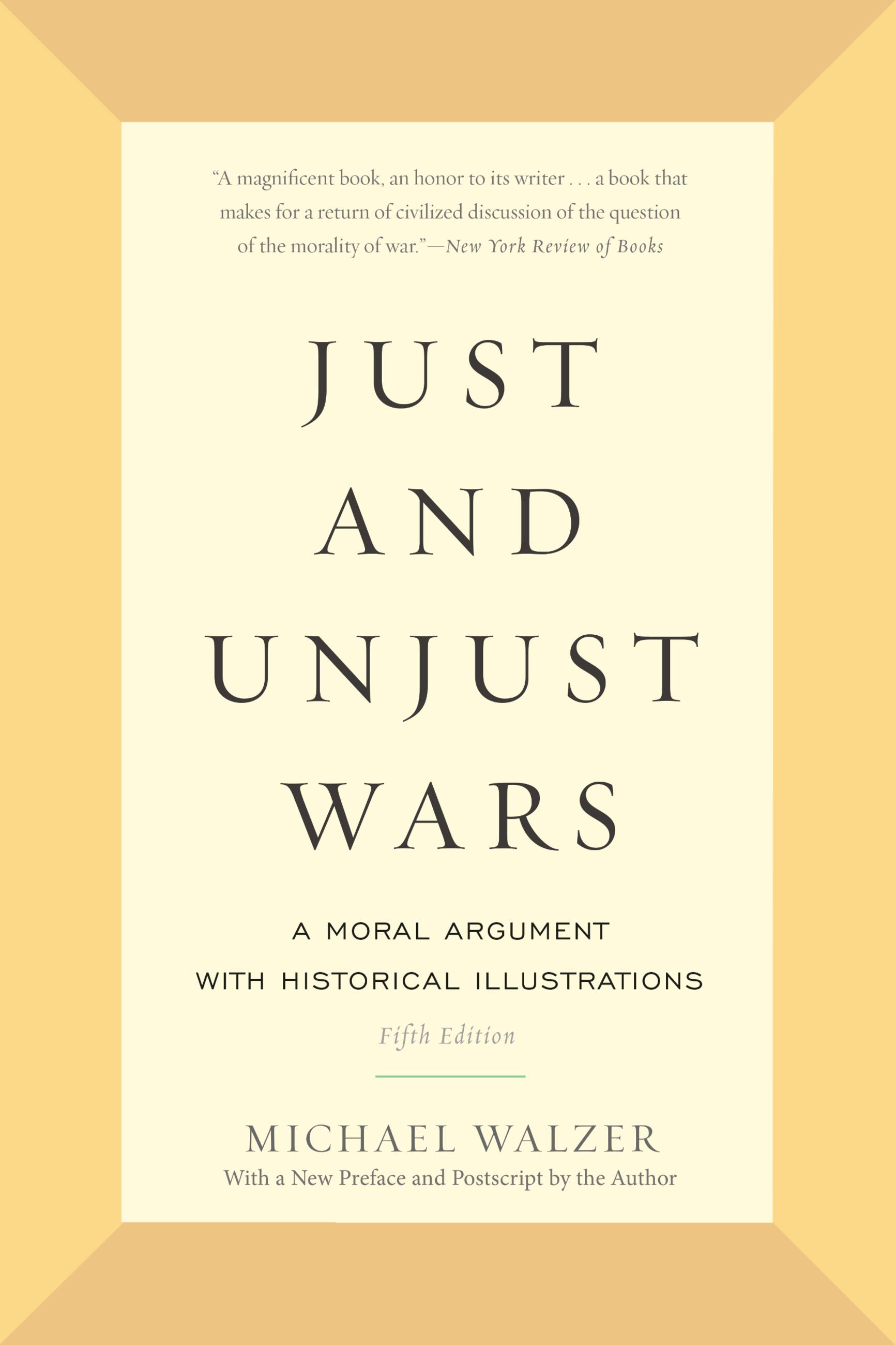
Just and Unjust Wars p.p1 {margin: 0.0px 0.0px 0.0px 0.0px; font: 12.0px 'Helvetica Neue'; color: #454545} p.p2 {margin: 0.0px 0.0px 0.0px 0.0px; font: 12.0px 'Helvetica Neue'; color: #454545; min-height: 14.0px} A penetrating investigation into moral and ethical questions raised by war, drawing on examples from antiquity to the present Just and Unjust Wars has forever changed how we think about the ethics of conflict. In this modern classic, political philosopher Michael Walzer examines the moral issues that arise before, during, and after the wars we fight. Reaching from the Athenian attack on Melos, to the Mai Lai massacre, to the current war in Afghanistan and beyond, Walzer mines historical and contemporary accounts and the testimony of participants, decision makers, and victims to explain when war is justified and what ethical limitations apply to those who wage it. POLITICAL SCIENCE,History & Theory
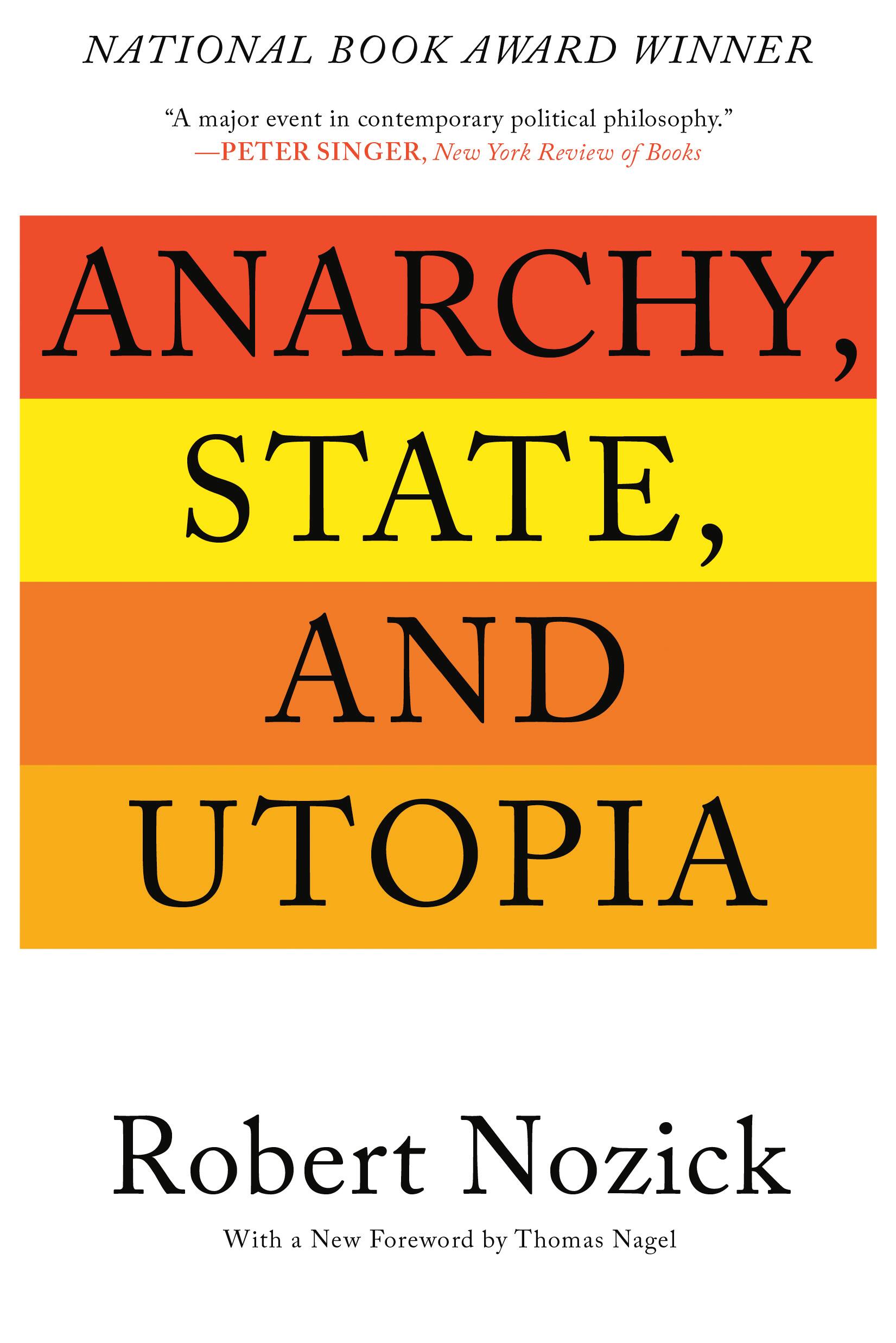
Anarchy, State, and Utopia In this brilliant and widely acclaimed book, winner of the 1975 National Book Award, Robert Nozick challenges the most commonly held political and social positions of our age -- liberal, socialist, and conservative. POLITICAL SCIENCE,History & Theory
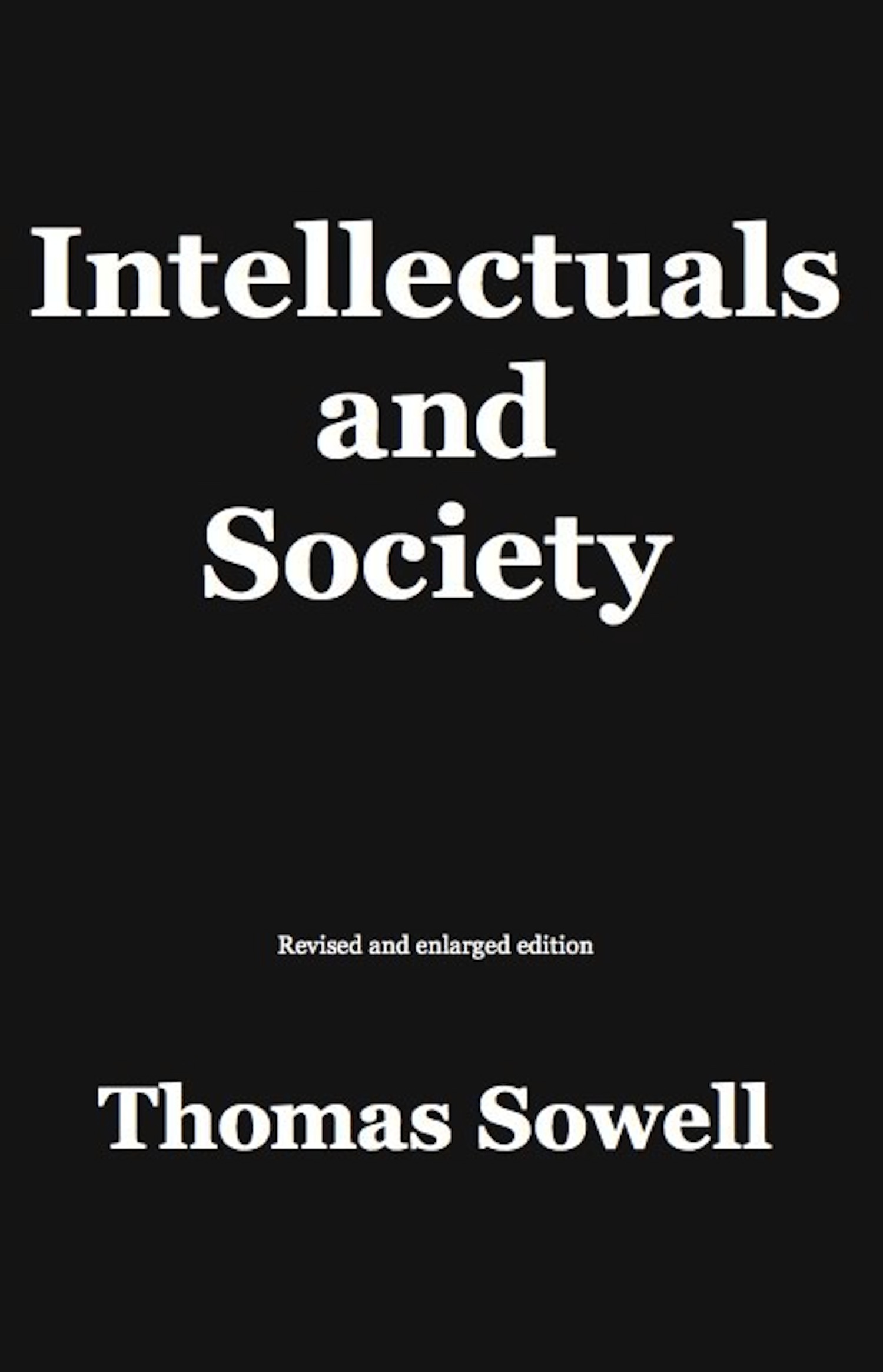
Intellectuals and Society The influence of intellectuals is not only greater than in previous eras but also takes a very different form from that envisioned by those like Machiavelli and others who have wanted to directly influence rulers. It has not been by shaping the opinions or directing the actions of the holders of power that modern intellectuals have most influenced the course of events, but by shaping public opinion in ways that affect the actions of power holders in democratic societies, whether or not those power holders accept the general vision or the particular policies favored by intellectuals. Even government leaders with disdain or contempt for intellectuals have had to bend to the climate of opinion shaped by those intellectuals. Intellectuals and Society not only examines the track record of intellectuals in the things they have advocated but also analyzes the incentives and constraints under which their views and visions have emerged. One of the most surprising aspects of this study is how often intellectuals have been proved not only wrong, but grossly and disastrously wrong in their prescriptions for the ills of society -- and how little their views have changed in response to empirical evidence of the disasters entailed by those views. POLITICAL SCIENCE,History & Theory
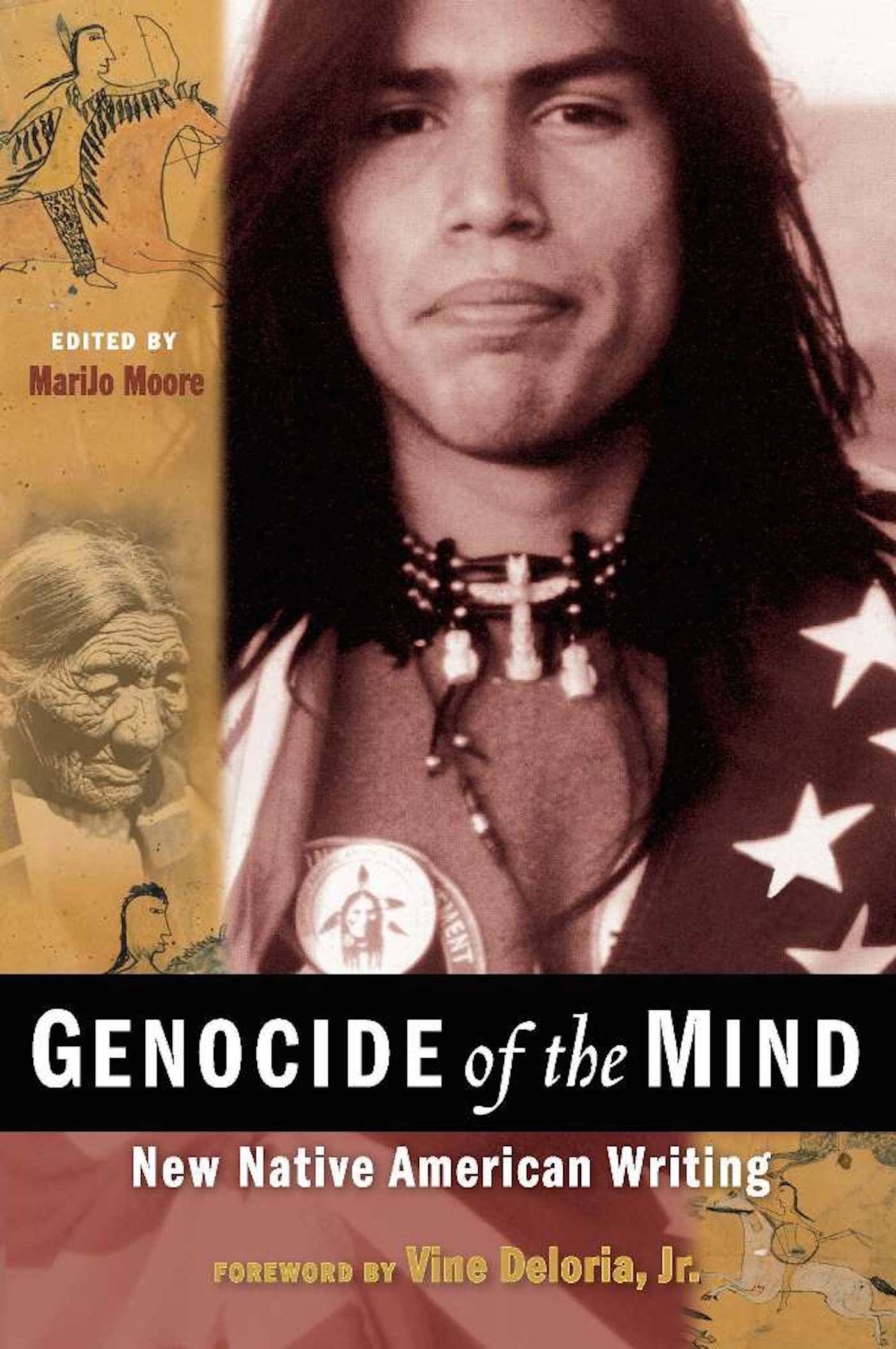
Genocide of the Mind After five centuries of Eurocentrism, many people have little idea that Native American tribes still exist, or which traditions belong to what tribes. However over the past decade there has been a rising movement to accurately describe Native cultures and histories. In particular, people have begun to explore the experience of urban Indians -- individuals who live in two worlds struggling to preserve traditional Native values within the context of an ever-changing modern society. In Genocide of the Mind, the experience and determination of these people is recorded in a revealing and compelling collection of essays that brings the Native American experience into the twenty-first century. Contributors include: Paula Gunn Allen, Simon Ortiz, Sherman Alexie, Leslie Marmon Silko, and Maurice Kenny, as well as emerging writers from different Indian nations. POLITICAL SCIENCE,History & Theory
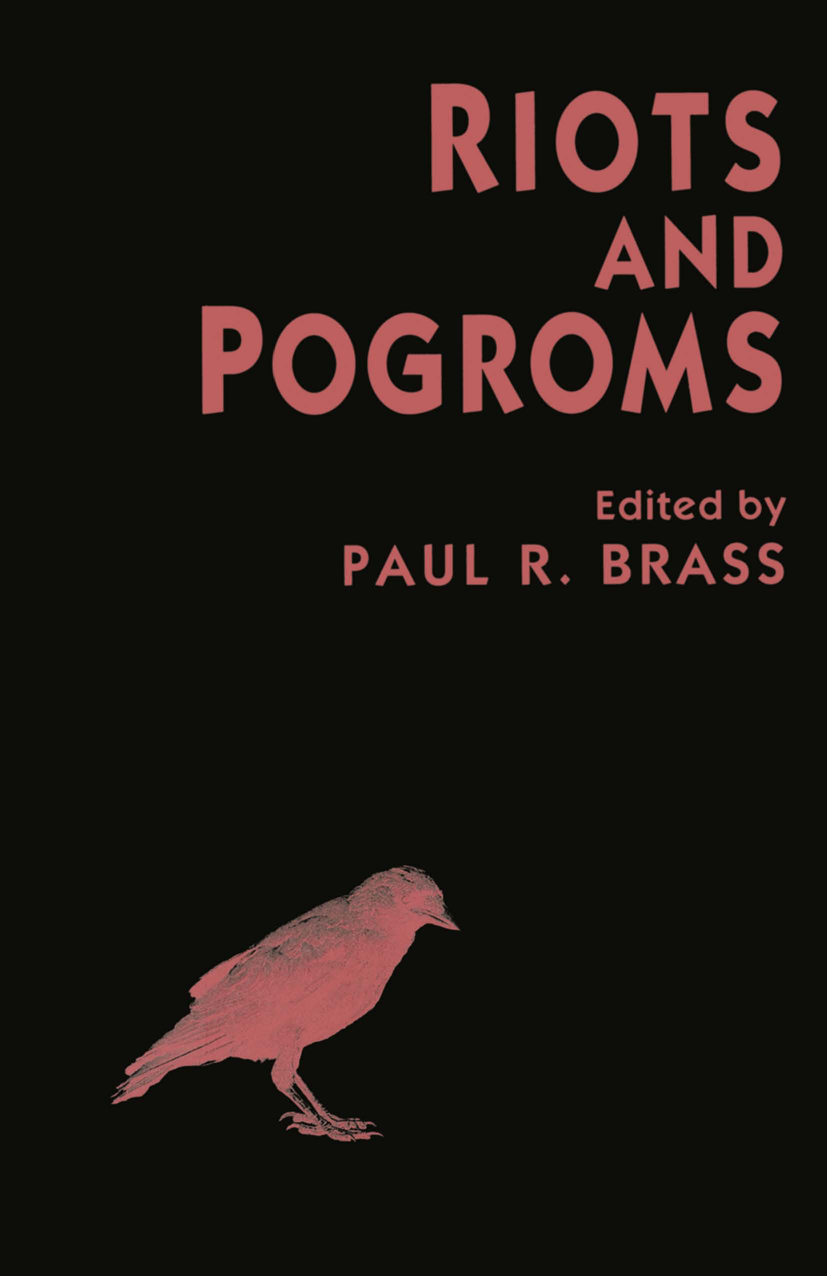
Riots and Pogroms Riots and Pogroms presents comparative studies of riots and pogroms in the twentieth century in Russia, Germany, Israel, India, and the United States, with a comparative, historical, and analytical introduction by the editor. The focus of the book is on the interpretive process which follows after the occurrence of riots and pogroms, rather than on the search for their causes. The concern of the editor and contributors is with the struggle for control over the meaning of riotous events, for the right to represent them properly. POLITICAL SCIENCE,History & Theory

Mistaken Identity A powerful challenge to the way we understand the politics of race and the history of anti-racist struggle Whether class or race is the more important factor in modern politics is a question right at the heart of recent history’s most contentious debates. Among groups who should readily find common ground, there is little agreement. To escape this deadlock, Asad Haider turns to the rich legacies of the black freedom struggle. Drawing on the words and deeds of black revolutionary theorists, he argues that identity politics is not synonymous with anti-racism, but instead amounts to the neutralization of its movements. It marks a retreat from the crucial passage of identity to solidarity, and from individual recognition to the collective struggle against an oppressive social structure. Weaving together autobiographical reflection, historical analysis, theoretical exegesis, and protest reportage, Mistaken Identity is a passionate call for a new practice of politics beyond colorblind chauvinism and “the ideology of race.” POLITICAL SCIENCE,History & Theory
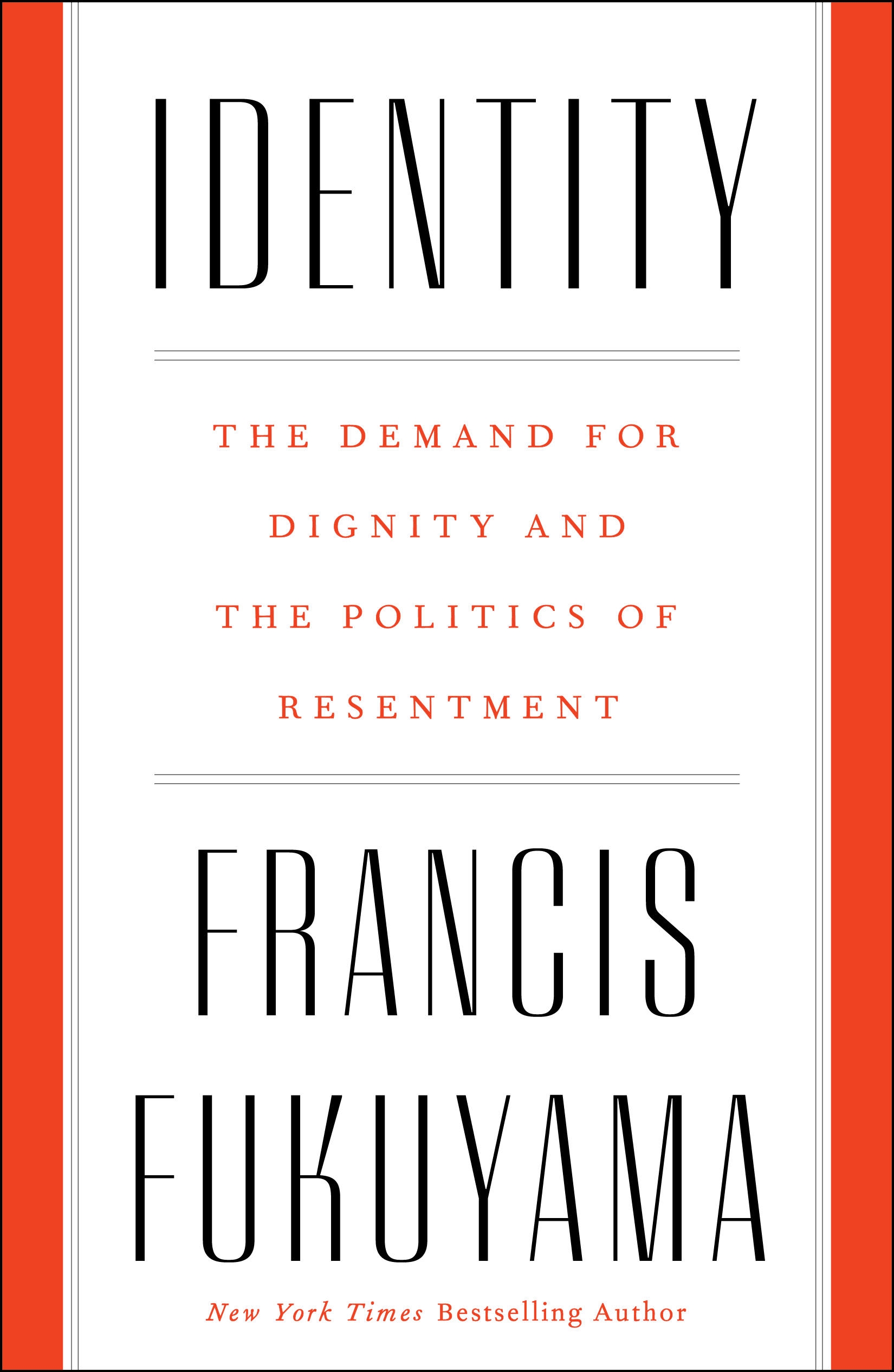
Identity The New York Times bestselling author of The Origins of Political Order offers a provocative examination of modern identity politics: its origins, its effects, and what it means for domestic and international affairs of state In 2014, Francis Fukuyama wrote that American institutions were in decay, as the state was progressively captured by powerful interest groups. Two years later, his predictions were borne out by the rise to power of a series of political outsiders whose economic nationalism and authoritarian tendencies threatened to destabilize the entire international order. These populist nationalists seek direct charismatic connection to “the people,†who are usually defined in narrow identity terms that offer an irresistible call to an in-group and exclude large parts of the population as a whole. Demand for recognition of one’s identity is a master concept that unifies much of what is going on in world politics today. The universal recognition on which liberal democracy is based has been increasingly challenged by narrower forms of recognition based on nation, religion, sect, race, ethnicity, or gender, which have resulted in anti-immigrant populism, the upsurge of politicized Islam, the fractious “identity liberalism†of college campuses, and the emergence of white nationalism. Populist nationalism, said to be rooted in economic motivation, actually springs from the demand for recognition and therefore cannot simply be satisfied by economic means. The demand for identity cannot be transcended; we must begin to shape identity in a way that supports rather than undermines democracy. Identity is an urgent and necessary book—a sharp warning that unless we forge a universal understanding of human dignity, we will doom ourselves to continuing conflict. POLITICAL SCIENCE,History & Theory
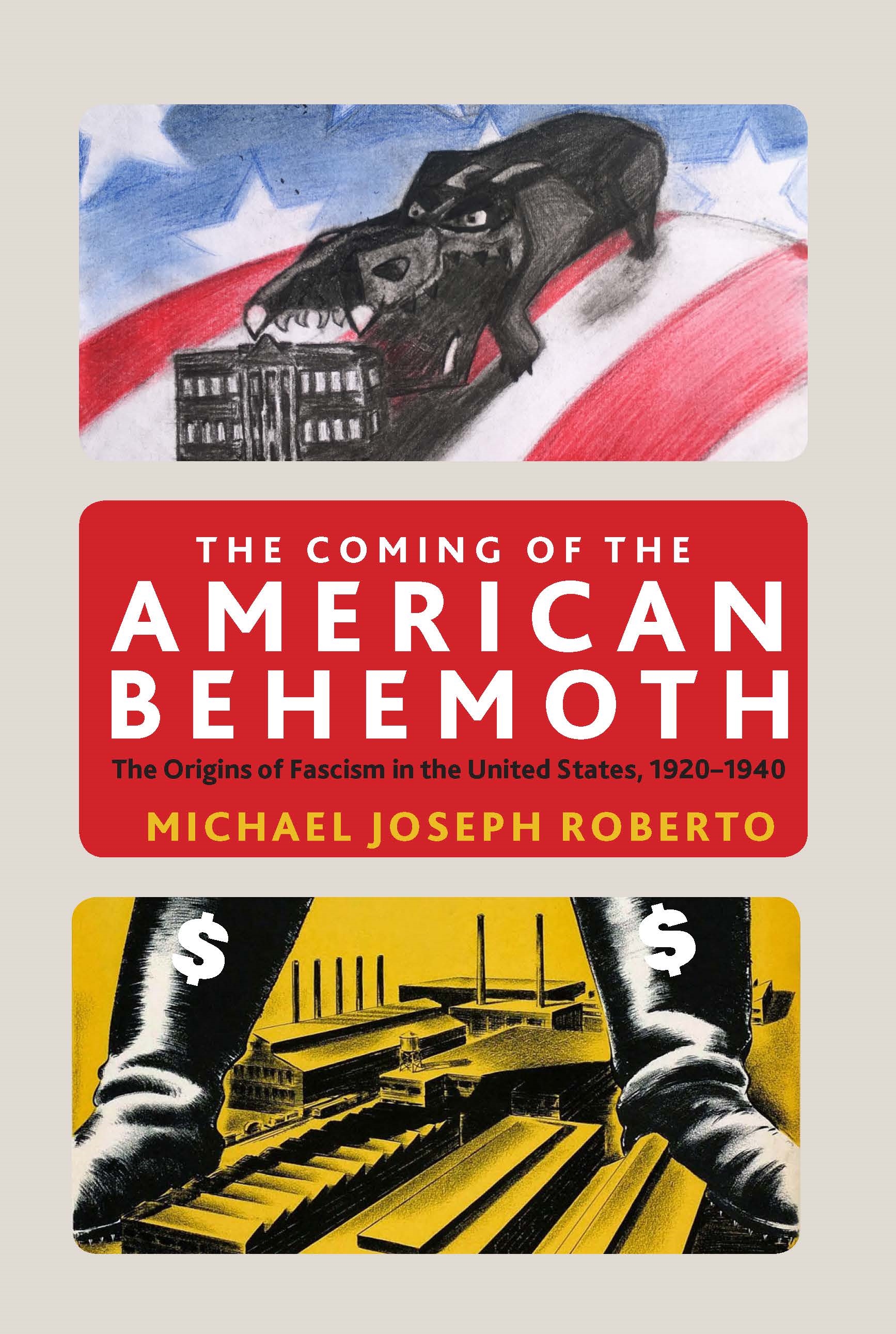
The Coming of the American Behemoth A primer on the history of American fascism Most people in the United States have been trained to recognize fascism in movements such as Germany’s Third Reich or Italy’s National Fascist Party, where charismatic demagogues manipulate incensed, vengeful masses. We rarely think of fascism as linked to the essence of monopoly-finance capitalism, operating under the guise of American free-enterprise. But, as Michael Joseph Roberto argues, this is exactly where fascism’s embryonic forms began gestating in the United States, during the so-called prosperous 1920s and the Great Depression of the following decade. Drawing from a range of authors who wrote during the 1930s and early 1940s, Roberto examines how the driving force of American fascism comes, not from reactionary movements below, but from the top, namely, Big Business and the power of finance capital. More subtle than its earlier European counterparts, writes Roberto, fascist America’s racist, top-down quashing of individual liberties masqueraded as “real democracy,†“upholding the Constitution,†and the pressure to be “100 Percent American.†The Coming of the American Behemoth is intended as a primer, to forge much-needed discourse on the nature of fascism, and its particular forms within the United States. The book focuses on the role of the capital-labor relationship during the period between the two World Wars, when the United States became the epicenter of the world-capitalist system. Concentrating on specific processes, which he characterizes as terrorist and non-terrorist alike, Roberto argues that the interwar period was a fertile time for the incubation of a protean, more salable form of tyranny – a fascist behemoth in the making, whose emergence has been ignored or dismissed by mainstream historians. This book is a necessity for anyone who fears America tipping ever closer, in this era of Trump, to full-blown fascism. POLITICAL SCIENCE,History & Theory

Mythologies of State and Monopoly Power An analysis of the mythologies that influence the American legal system “Mythologies,†writes veteran human rights lawyer Michael Tigar, “are structures of words and images that portray people, institutions, and events in ways that mask an underlying reality.†For instance, the “Justice Department†appears, by its very nature and practice, to appropriate “justice†as the exclusive property of the federal government. In his brilliantly acerbic collection of essays, Tigar reveals, deconstructs, and eviscerates mythologies surrounding the U.S. criminal justice system, racism, free expression, workers’ rights, and international human rights. Lawyers confront mythologies in the context of their profession. But the struggle for human liberation makes mythology-busting the business of all of us. The rights we have learned to demand are not only trivialized in our current system of social relations; they are, in fact, antithetical to that system. With wit and eloquence, Michael Tigar draws on legal cases, philosophy, literature, and fifty-years’ experience as an attorney, activist, and teacher to bust the mythologies and to argue for real change. POLITICAL SCIENCE,History & Theory

The Politics of Bureaucracy Written by B. Guy Peters, a leading authority in the field, this comprehensive exploration of the political and policy making roles of public bureaucracies is now available in a fully revised seventh edition, offering extensive, well-documented comparative analysis of the effects of politics on bureaucracy. Updates to this edition include: All new coverage of public administration in Latin America and Africa, with special attention paid to the impact of New Public Management and other ideas for reform; An examination of the European Union and its effects on public policy and public administration in member countries, as well as an exploration of the EU as a particular type of bureaucracy; A renewed emphasis on coordination and the role of central agencies; A thorough assessment of 'internationalization' of bureaucracies and concerns with the role of international pressures on domestic governments and organizations in the public sector; Coverage of the wide-ranging impacts of the 2008 economic slowdown on public bureaucracies and public policies, and the varied success of governmental responses to the crisis. Drawing on evidence from a wide variety of political systems, The Politics of Bureaucracy, Seventh Edition, continues to be essential reading for all students of government, policy analysis, politics, and international relations. POLITICAL SCIENCE,History & Theory
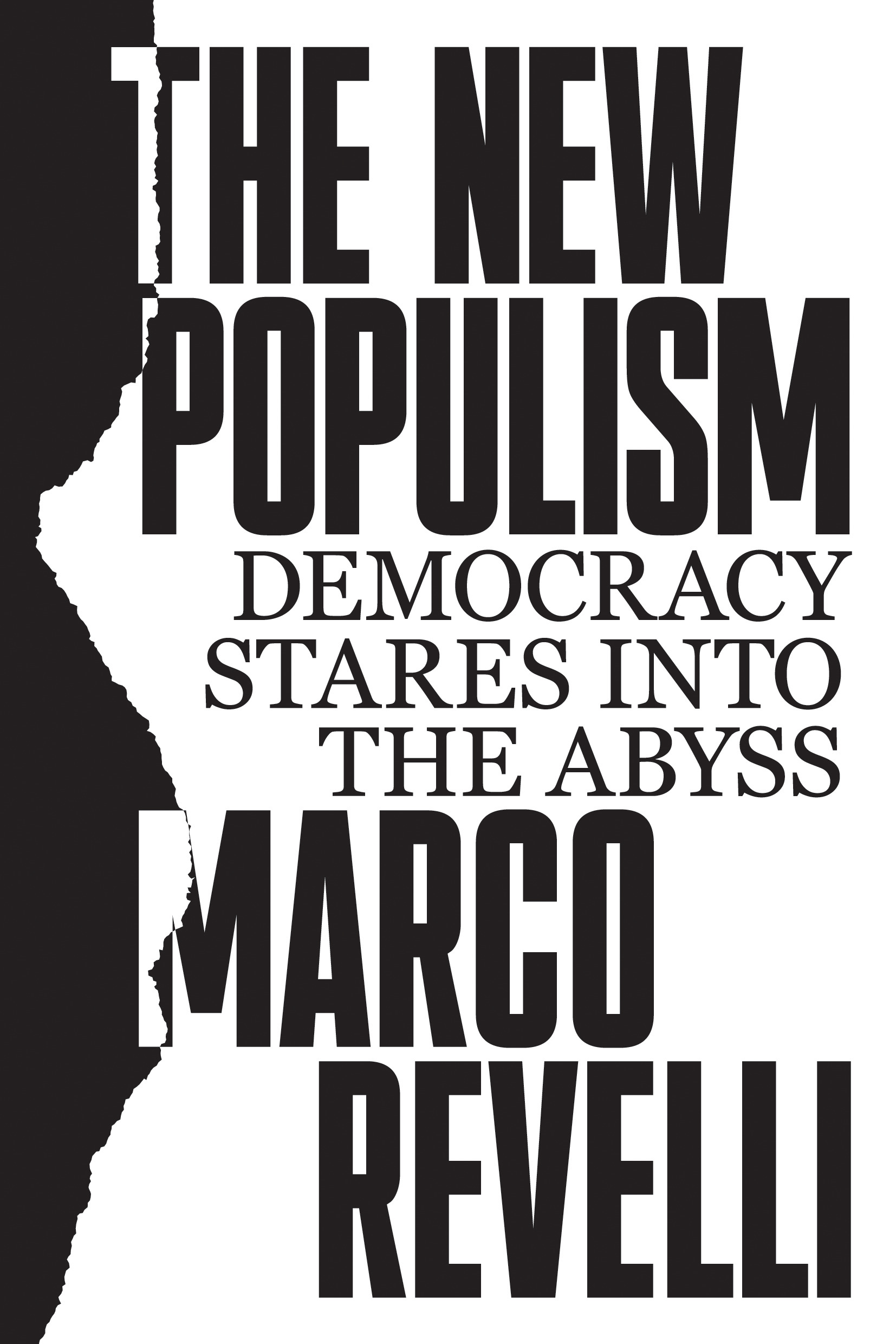
The New Populism A crisp and trenchant dissection of populism today The word 'populism' has come to cover all manner of sins. Yet despite the prevalence of its use, it is often difficult to understand what connects its various supposed expressions. From Syriza to Trump and from Podemos to Brexit, the electoral earthquakes of recent years have often been grouped under this term. But what actually defines 'populism'? Is it an ideology, a form of organisation, or a mentality? Marco Revelli seeks to answer this question by getting to grips with the historical dynamics of so-called 'populist' movements. While in the early days of democracy, populism sought to represent classes and social layers who asserted their political role for the first time, in today's post-democratic climate, it instead expresses the grievances of those who had until recently felt that they were included. Having lost their power, the disinherited embrace not a political alternative to -isms like liberalism or socialism, but a populist mood of discontent. The new populism is the 'formless form' that protest and grievance assume in the era of financialisation, in the era where the atomised masses lack voice or organisation. For Revelli, this new populism the child of an age in which the Left has been hollowed out and lost its capacity to offer an alternative. POLITICAL SCIENCE,History & Theory
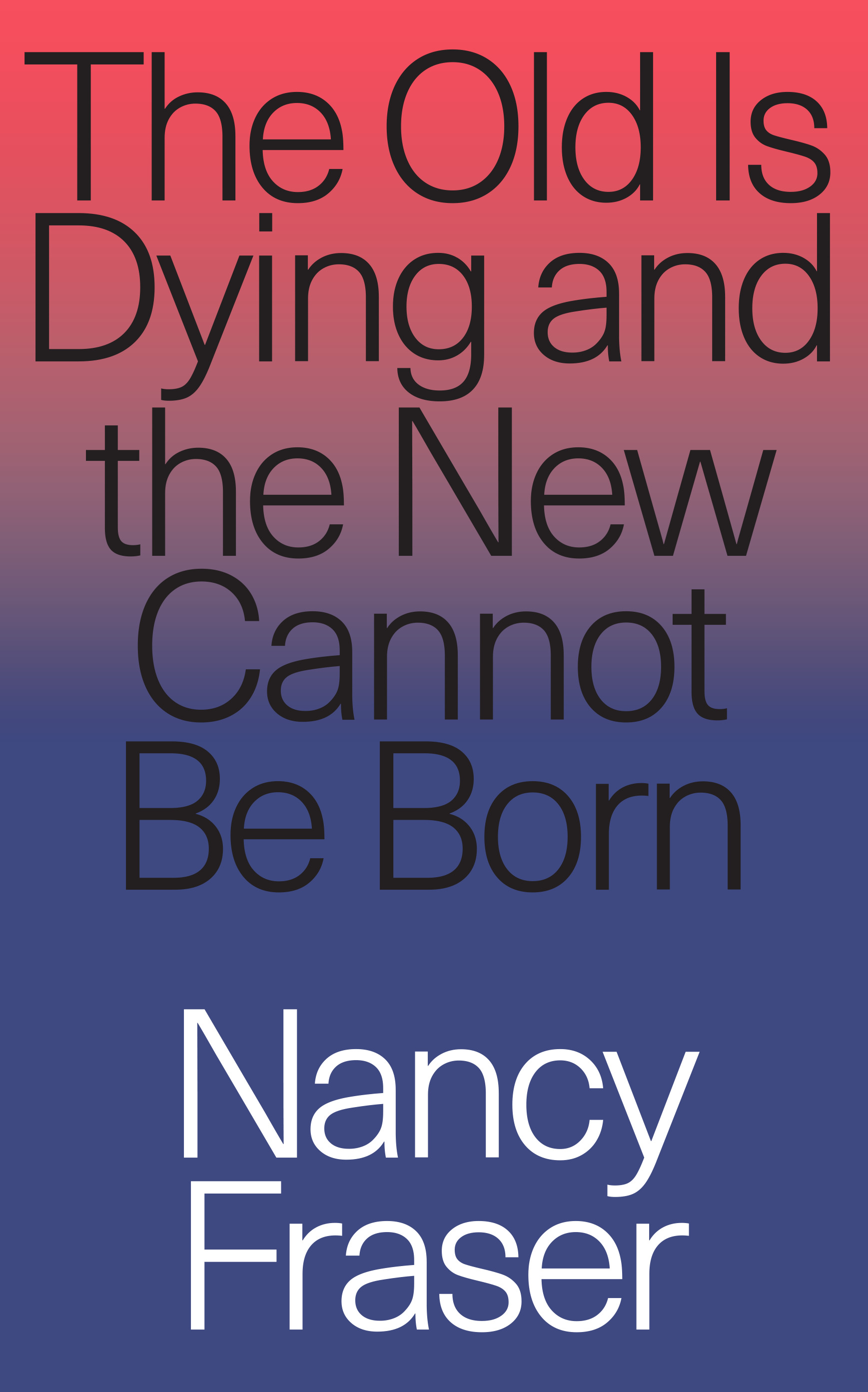
The Old is Dying and the New Cannot Be Born Neoliberalism is fracturing, but what will emerge in its wake? The global political, ecological, economic, and social breakdown—symbolized by Trump’s election—has destroyed faith that neoliberal capitalism is beneficial to the majority. Nancy Fraser explores how this faith was built through the late twentieth century by balancing two central tenets: recognition (who deserves rights) and distribution (who deserves income). When these begin to fray, new forms of outsider populist politics emerge on the left and the right. These, Fraser argues, are symptoms of the larger crisis of hegemony for neoliberalism, a moment when, as Gramsci had it, “the old is dying and the new cannot be born.” In an accompanying interview with Jacobin publisher Bhaskar Sunkara, Fraser argues that we now have the opportunity to build progressive populism into an emancipatory social force. POLITICAL SCIENCE,History & Theory

The American Road Trip and American Political Thought It’s hard to imagine the American dream without American road trips. This book takes readers on a journey through American road trip stories, revealing that they involve more than mere escapism—that they are an important and long-neglected source of American political thought. POLITICAL SCIENCE,History & Theory

Covenant and Polity in Biblical Israel In this first volume of a trilogy, Daniel J. Elazar addresses political uses of the idea of covenant, the tradition that has adhered to that idea, and the political arrangements that flow from it, Among the topics covered are covenant as a political concept, the Bible as a political commentary, the post-biblical tradition, medieval covenant theory, and Jewish political culture. POLITICAL SCIENCE,History & Theory
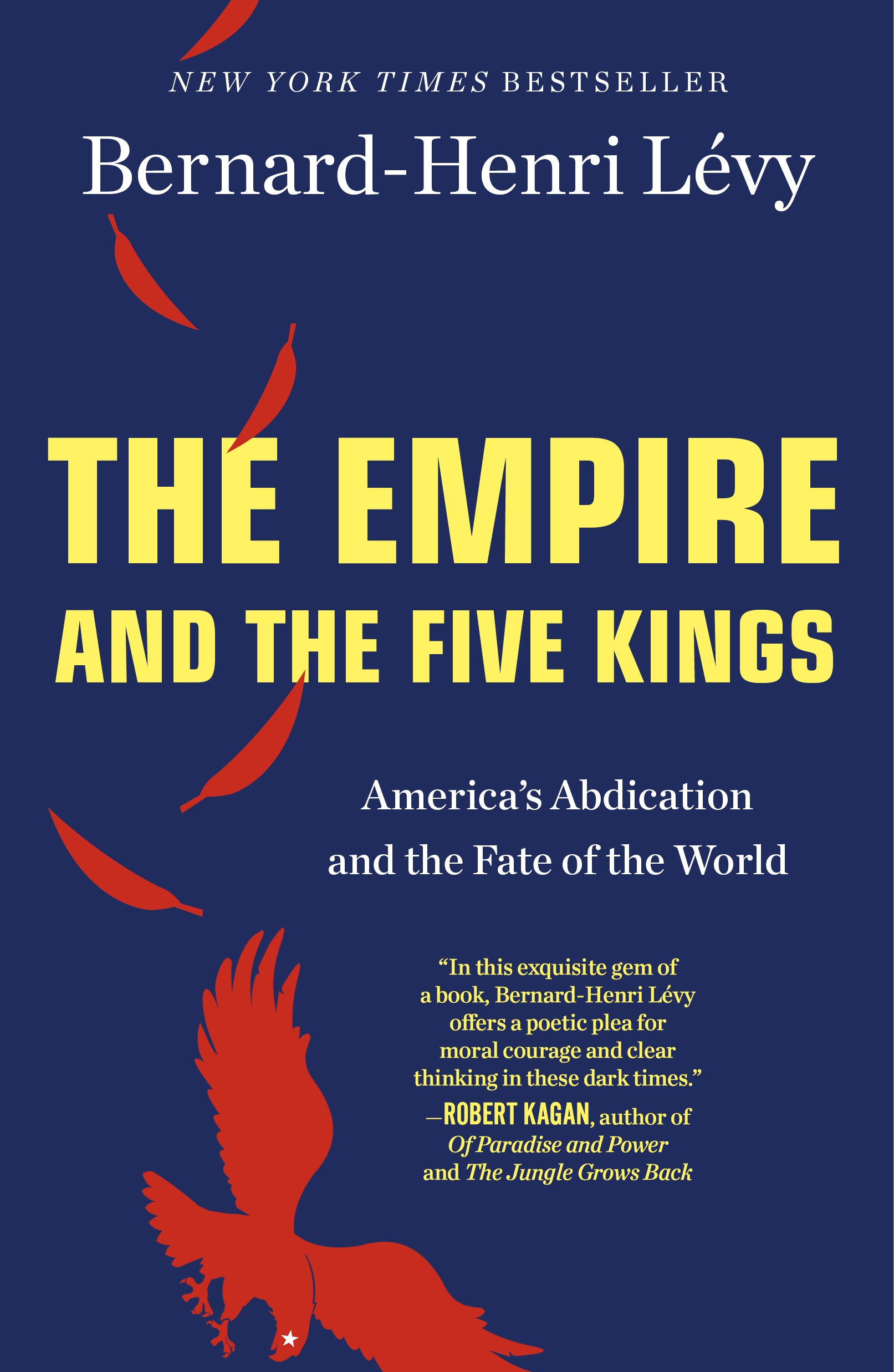
The Empire and the Five Kings One of the West’s leading intellectuals offers a provocative look at America’s withdrawal from world leadership and the rising powers who seek to fill the vacuum left behind. The United States was once the hope of the world, a beacon of freedom and the defender of liberal democracy. Nations and peoples on all continents looked to America to stand up for the values that created the Western worldand to oppose autocracy and repression. Even when America did not live up to its ideals, it still recognized their importance, at home and abroad. But as Bernard-Henri Lévy lays bare in this powerful and disturbing analysis of the world today, America is retreating from its traditional leadership role, and in its place have come five ambitious powers, former empires eager to assert their primacy and influence. Lévy shows how these five—Russia, China, Turkey, Iran, and Sunni radical Islamism—are taking steps to undermine the liberal values that have been a hallmark of Western civilization. The Empire and the Five Kings is a cri de coeur that draws upon lessons from history and the eternal touchstones of human culture to reveal the stakes facing the West as America retreats from its leadership role, a process that did not begin with Donald Trump's presidency and is not likely to end with him. The crisis is one whose roots can be found as far back as antiquity and whose resolution will require the West to find a new way forward if its principles and values are to survive. As seen on Real Time with Bill Maher (2/22/2019) and Fareed Zakaria GPS (2/17/2019). POLITICAL SCIENCE,History & Theory
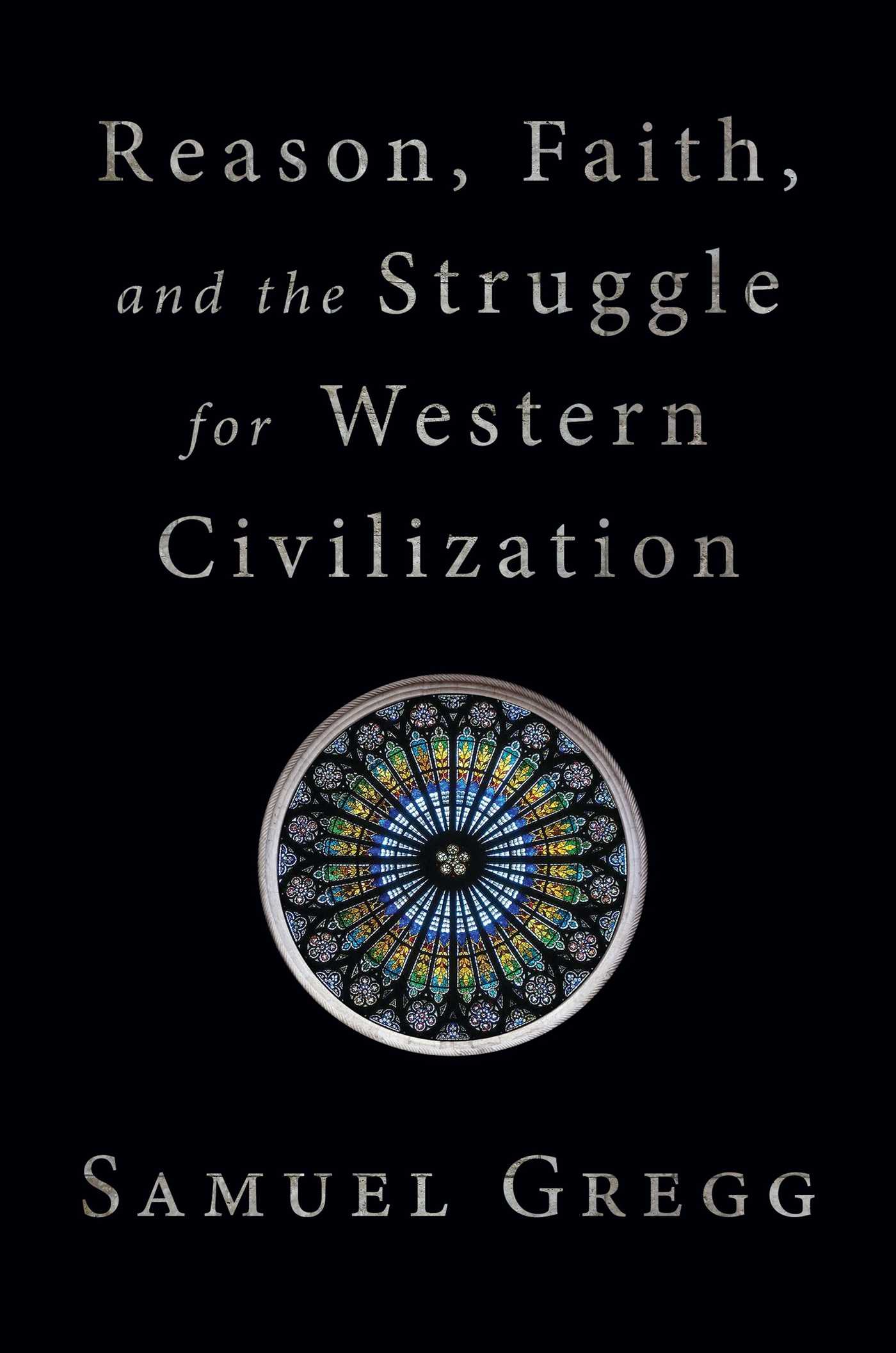
Reason, Faith, and the Struggle for Western Civilization "Gregg's book is the closet thing I've encountered in a long time to a one-volume user's manual for operating Western Civilization." —The Stream "Reason, Faith, and the Struggle for Western Civilization offers a concise intellectual history of the West through the prism of the relationship between faith and reason." —Free Beacon The genius of Western civilization is its unique synthesis of reason and faith. But today that synthesis is under attack—from the East by radical Islam (faith without reason) and from within the West itself by aggressive secularism (reason without faith). The stakes are incalculably high. The naïve and increasingly common assumption that reason and faith are incompatible is simply at odds with the facts of history. The revelation in the Hebrew Scriptures of a reasonable Creator imbued Judaism and Christianity with a conviction that the world is intelligible, leading to the flowering of reason and the invention of science in the West. It was no accident that the Enlightenment took place in the culture formed by the Jewish and Christian faiths. We can all see that faith without reason is benighted at best, fanatical and violent at worst. But too many forget that reason, stripped of faith, is subject to its own pathologies. A supposedly autonomous reason easily sinks into fanaticism, stifling dissent as bigoted and irrational and devouring the humane civilization fostered by the integration of reason and faith. The blood-soaked history of the twentieth century attests to the totalitarian forces unleashed by corrupted reason. But Samuel Gregg does more than lament the intellectual and spiritual ruin caused by the divorce of reason and faith. He shows that each of these foundational principles corrects the other’s excesses and enhances our comprehension of the truth in a continuous renewal of civilization. By recovering this balance, we can avoid a suicidal winner-take-all conflict between reason and faith and a future that will respect neither. POLITICAL SCIENCE,History & Theory
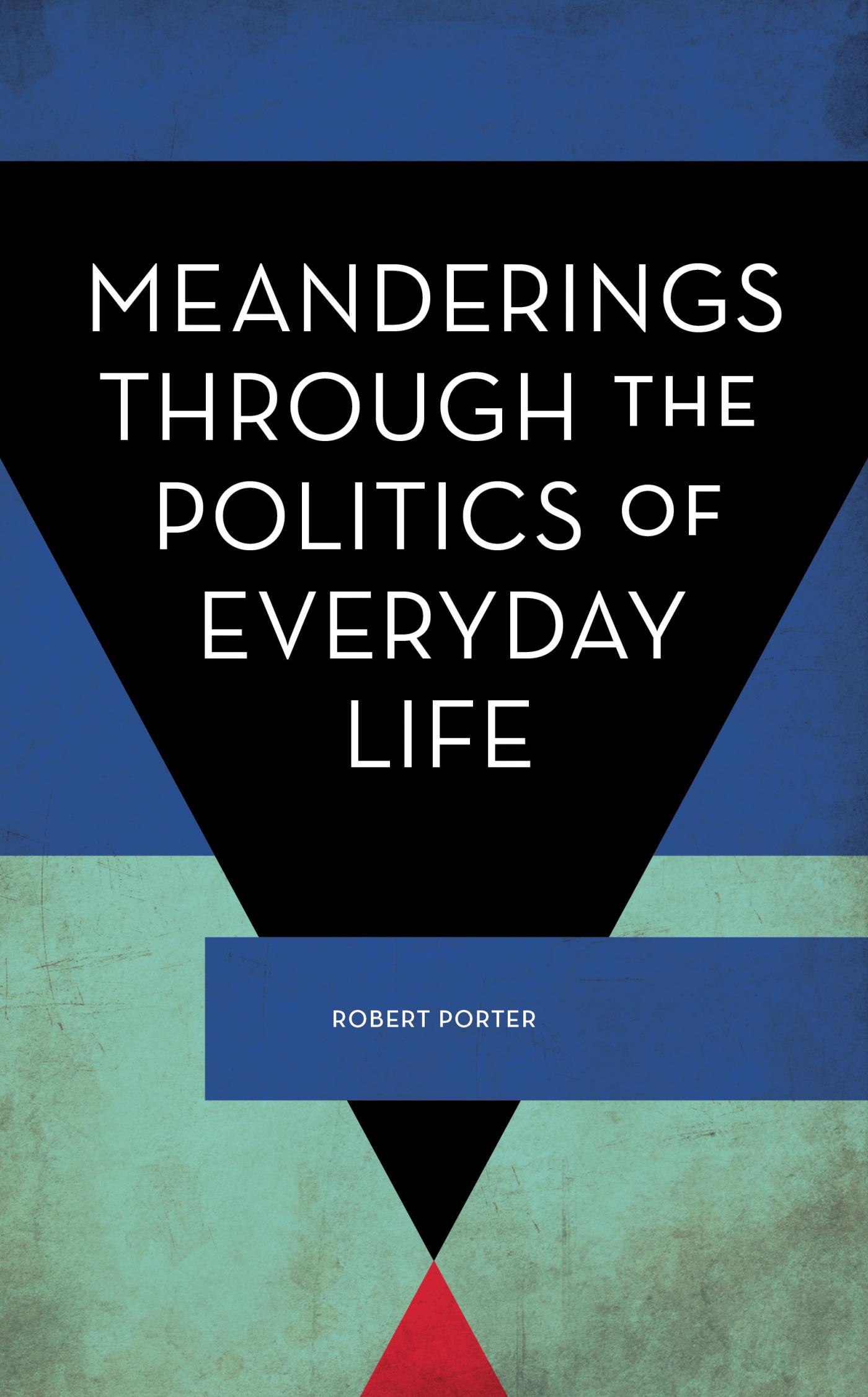
Meanderings Through the Politics of Everyday Life The key point of the book, ideally as well as practically, is to realize that there may be something potentially significant, and politically significant , in the very act of making such connections, of understanding the supposedly trite and trivial world of the everyday against a broader political backcloth. POLITICAL SCIENCE,History & Theory
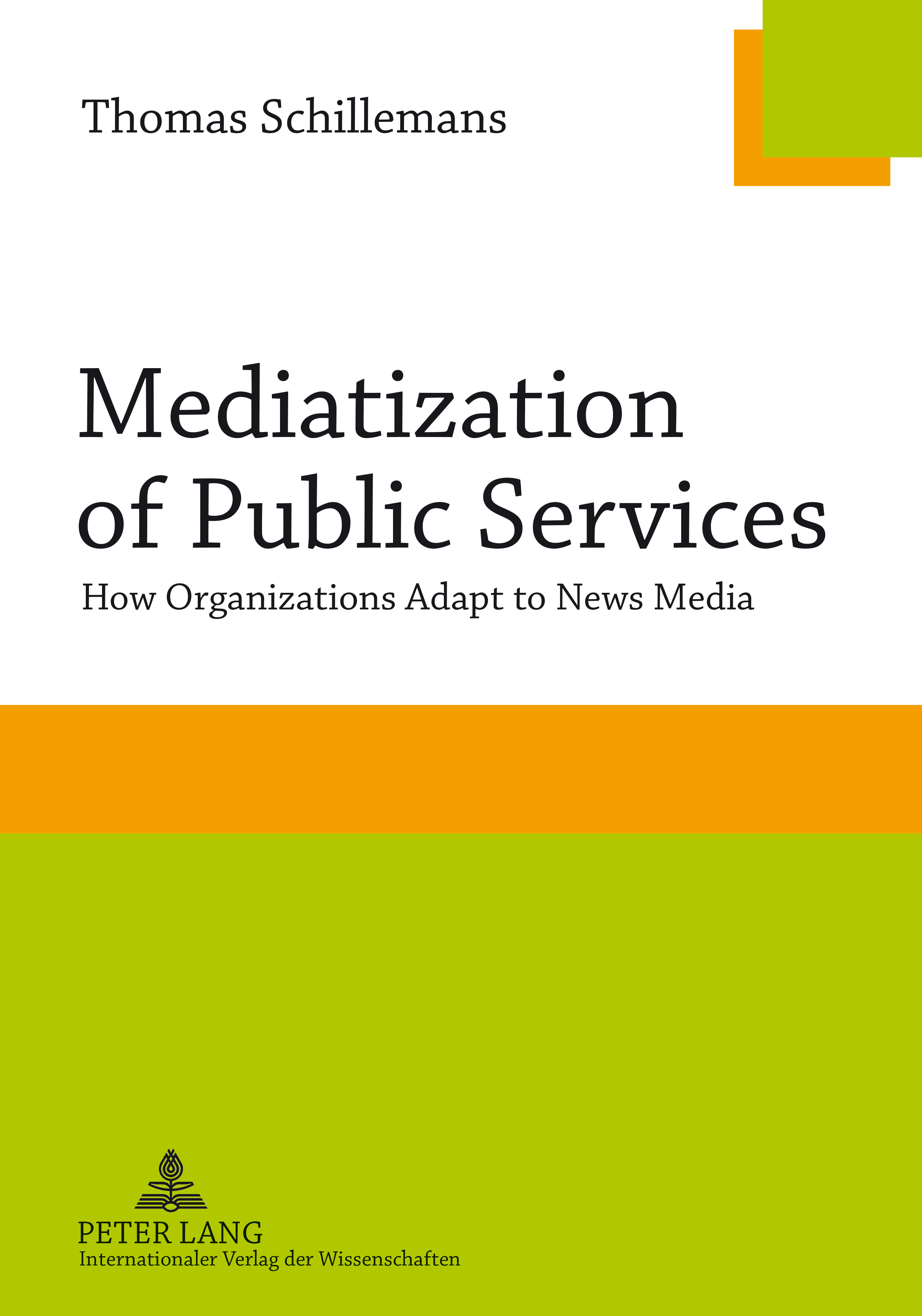
Mediatization of Public Services Public services are increasingly delivered by organizations operating at arms’ length of governments. These organizations occupy one third of the total news and spend huge sums of money on media management. This book provides the first comprehensive analysis of how public services are affected by their media environment. It describes how public service providers have become mediatized: have adapted their structures and processes to media pressure. The adaptation is profound; some managers use 25% of their time on media and others state that «from day one, how to get it through the media is on your mind». This normative issue of media influence is approached on the basis of extensive international research. At display is a collection of inside stories from the daily encounters between media and public service providers. POLITICAL SCIENCE,History & Theory
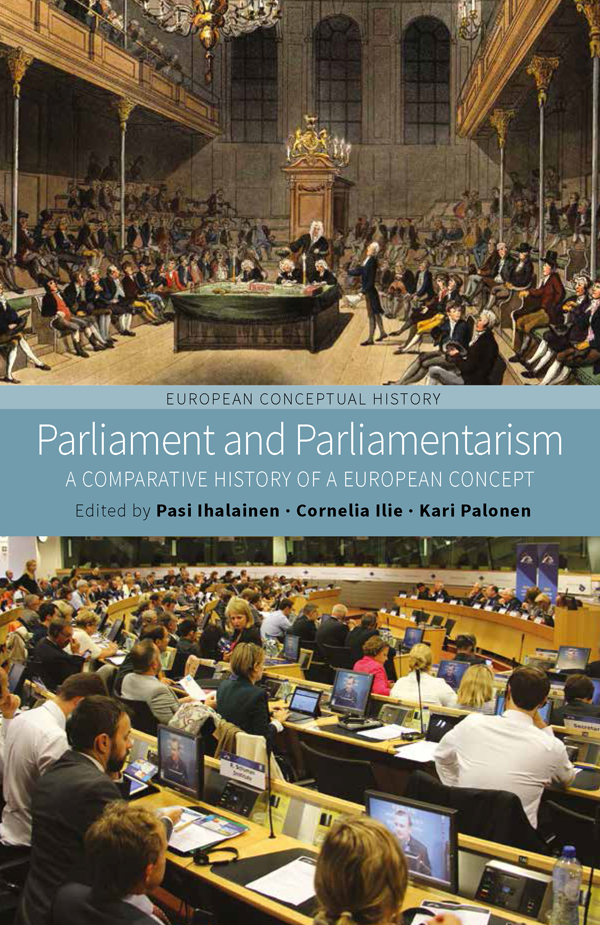
Parliament and Parliamentarism Parliamentary theory, practices, discourses, and institutions constitute a distinctively European contribution to modern politics. Taking a broad historical perspective, this cross-disciplinary, innovative, and rigorous collection locates the essence of parliamentarism in four key aspects—deliberation, representation, responsibility, and sovereignty—and explores the different ways in which they have been contested, reshaped, and implemented in a series of representative national and regional case studies. As one of the first comparative studies in conceptual history, this volume focuses on debates about the nature of parliament and parliamentarism within and across different European countries, representative institutions, and genres of political discourse. POLITICAL SCIENCE,History & Theory
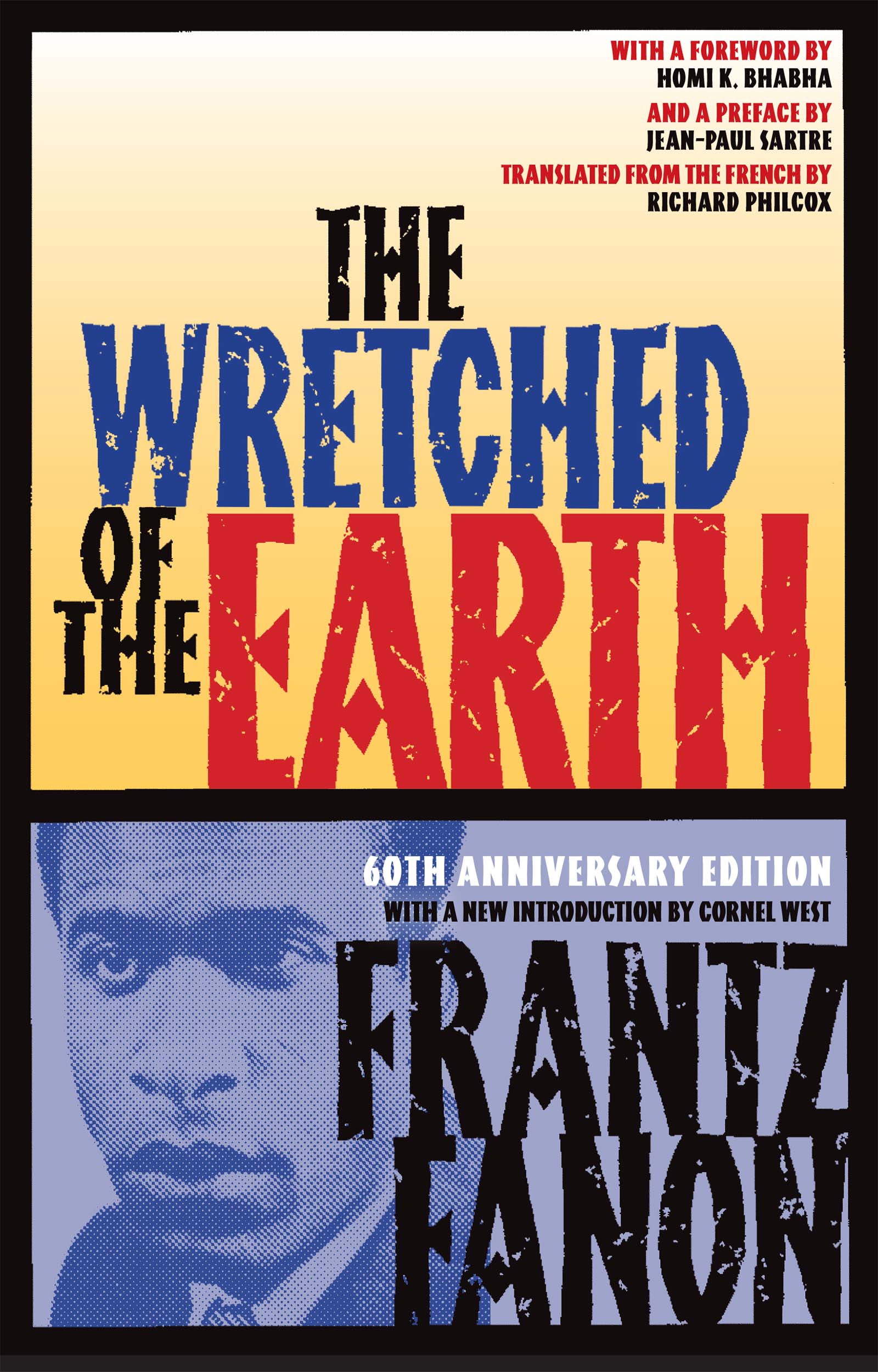
The Wretched of the Earth Frantz Fanon was one of the twentieth century’s most important theorists of revolution, colonialism, and racial difference, and this, his masterwork, is a classic alongside Orientalism and The Autobiography of Malcolm X. The Wretched of the Earth is a brilliant analysis of the psychology of the colonized and their path to liberation. Bearing singular insight into the rage of colonized peoples and the role of violence in historical change, the book also incisively attacks postindependence disenfranchisement of the masses by the elite on one hand, and intertribal and interfaith animosities on the other. A veritable handbook of social reorganization for leaders of emerging nations, The Wretched of the Earth has had a major impact on civil rights, anticolonialism, and black-consciousness movements around the world. This new translation updates its language for a new generation of readers and its lessons are more vital now than ever. POLITICAL SCIENCE,History & Theory
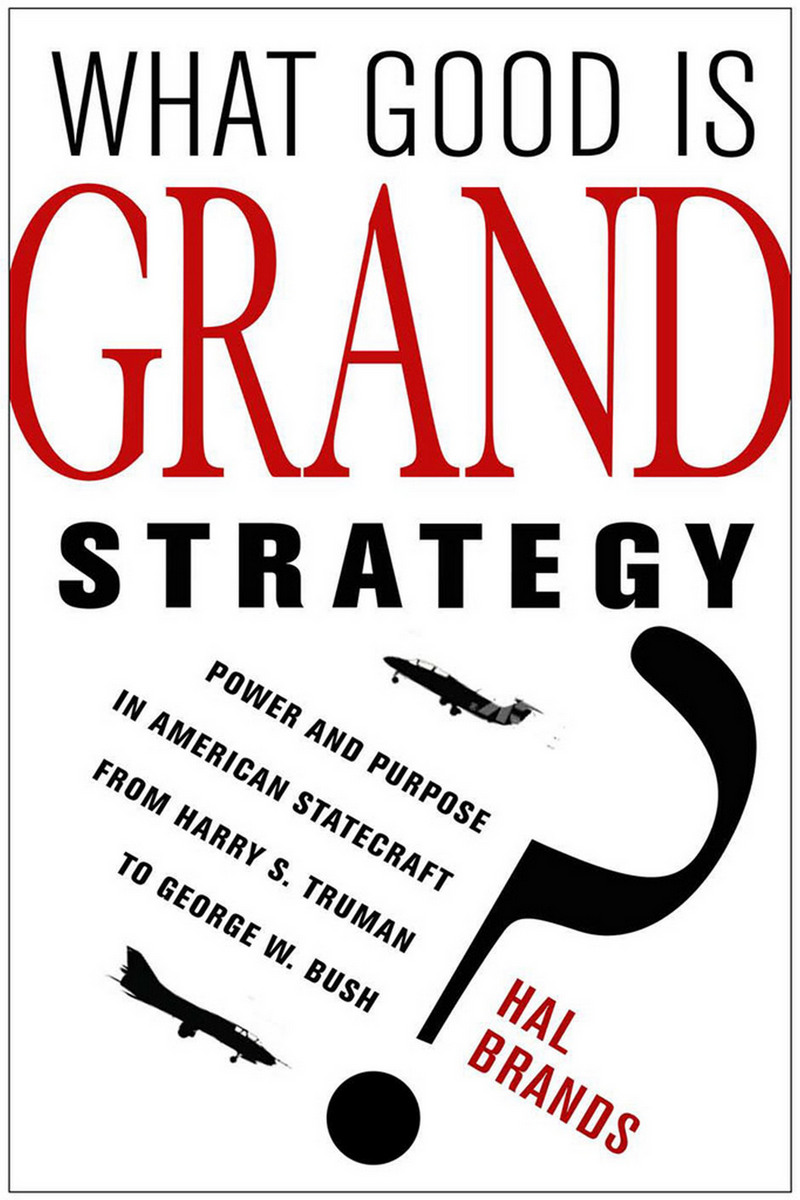
What Good Is Grand Strategy? Hal Brands explains why grand strategy is a concept that is so alluring and so elusive to those who make American statecraft, exploring what grand strategy is, why it is so essential, and why it is so hard to get right. POLITICAL SCIENCE,History & Theory
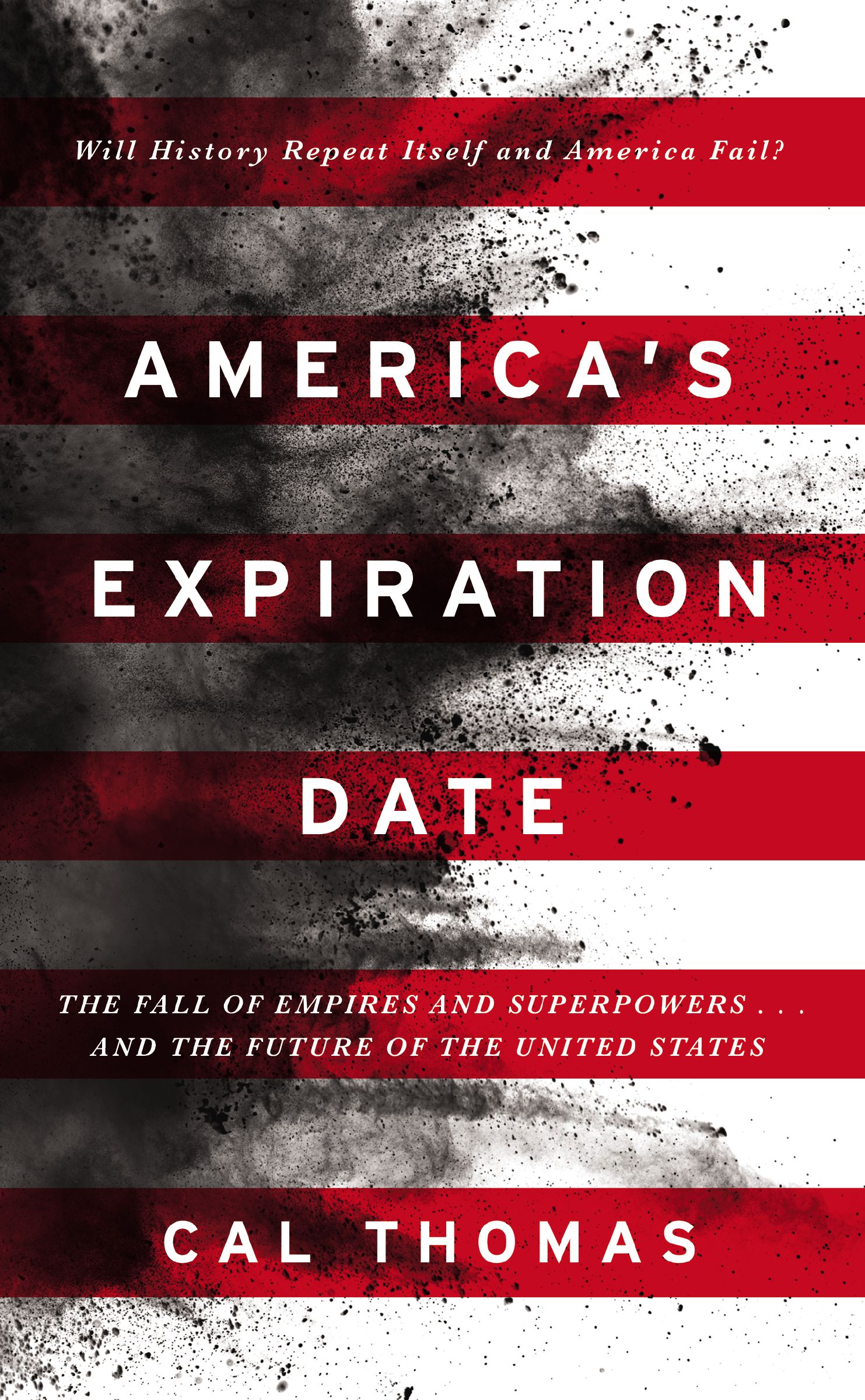
America's Expiration Date Many Americans, regardless of political affiliation, are anxious about the future of the “land that we love.†In America's Expiration Date, trusted political commentator Cal Thomas offers a diagnosis of what’s wrong with the United States and prophetically reminds us that change will come when Americans look to God instead of Washington. POLITICAL SCIENCE,History & Theory

The US Antifascism Reader How anti-fascism is as American as apple pie Since the birth of fascism in the 1920s, well before the global renaissance of “white nationalism,” the United States has been home to its own distinct fascist movements, some of which decisively influenced the course of US history. Yet long before “antifa” became a household word in the United States, they were met, time and again, by an equally deep antifascist current. Many on the left are unaware that the United States has a rich antifascist tradition, because it has rarely been discussed as such, nor has it been accessible in one place. This reader reconstructs the history of US antifascism into the twenty-first century, showing how generations of writers, organizers, and fighters spoke to each other over time. Spanning the 1930s to the present, this chronologically-arranged, primary source reader is made up of antifascist writings by Americans and by exiles in the US, some instantly recognizable, others long-forgotten. It also includes a sampling of influential writings from the US fascist, white nationalist, and proto-fascist traditions. Its contents, mostly written by people embedded in antifascist movements, include a number of pieces produced abroad that deeply influenced the US left. The collection thus places US antifascism in a global context. POLITICAL SCIENCE,History & Theory
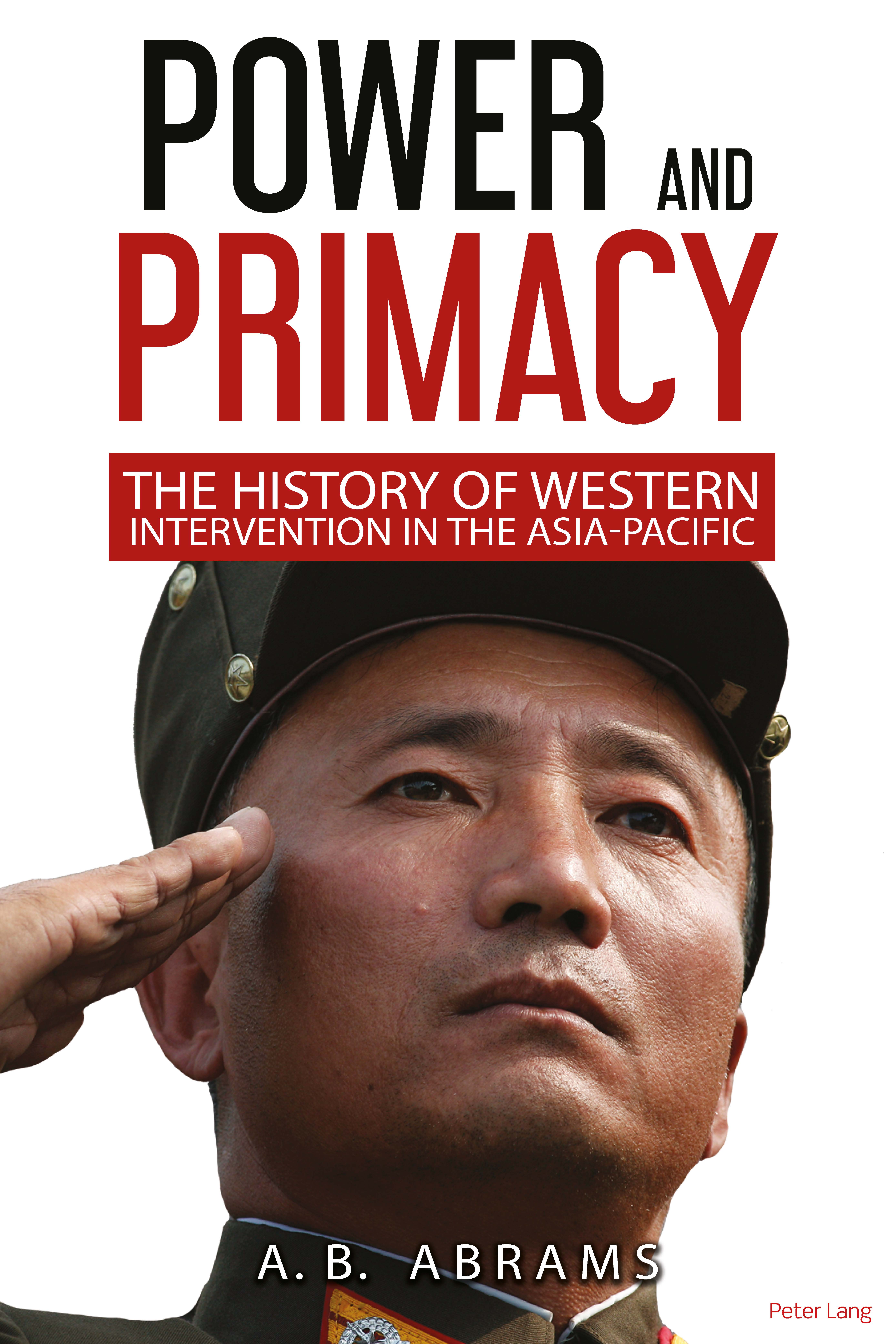
Power and Primacy This book attempts to elucidate the complex and little-known history of western intervention in the Asia-Pacific region, providing information critical to understanding contemporary developments there. POLITICAL SCIENCE,History & Theory
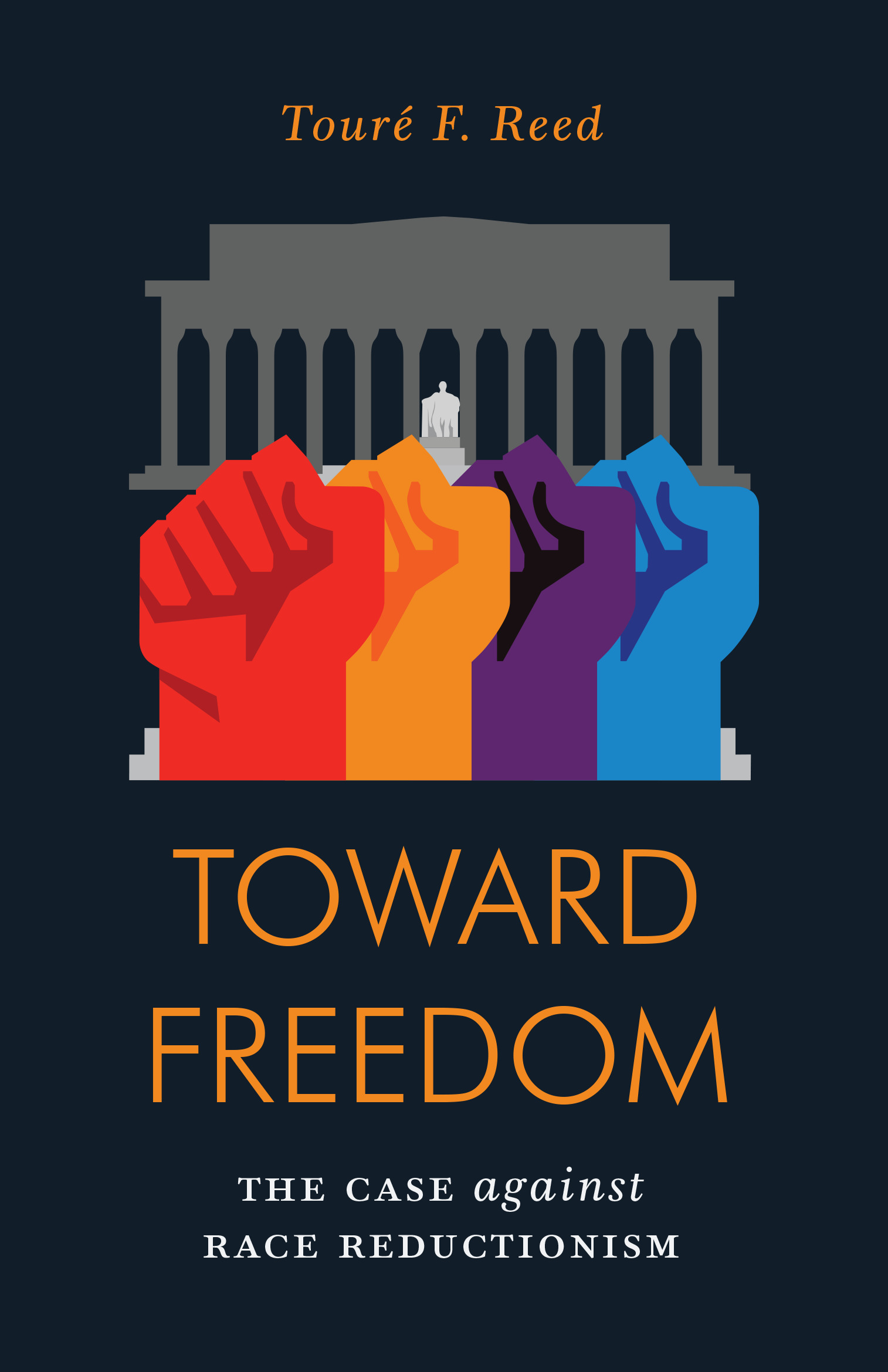
Toward Freedom The fate of poor and working-class African Americans-who are unquestionably represented among neoliberalism's victims-is inextricably linked to that of other poor and working-class Americans Reed contends that the road to a more just society for African Americans and everyone else is obstructed, in part, by a discourse that equates entrepreneurialism with freedom and independence. This, ultimately, insists on divorcing race and class. In the age of runaway inequality and Black Lives Matter, there is an emerging consensus that our society has failed to redress racial disparities. The culprit, however, is not the sway of a metaphysical racism or the modern survival of a primordial tribalism. Instead, it can be traced to far more comprehensible forces, such as the contradictions in access to New Deal era welfare programs, the blinders imposed by the Cold War, and Ronald Reagan's neoliberal assault on the half-century long Keynesian consensus. POLITICAL SCIENCE,History & Theory
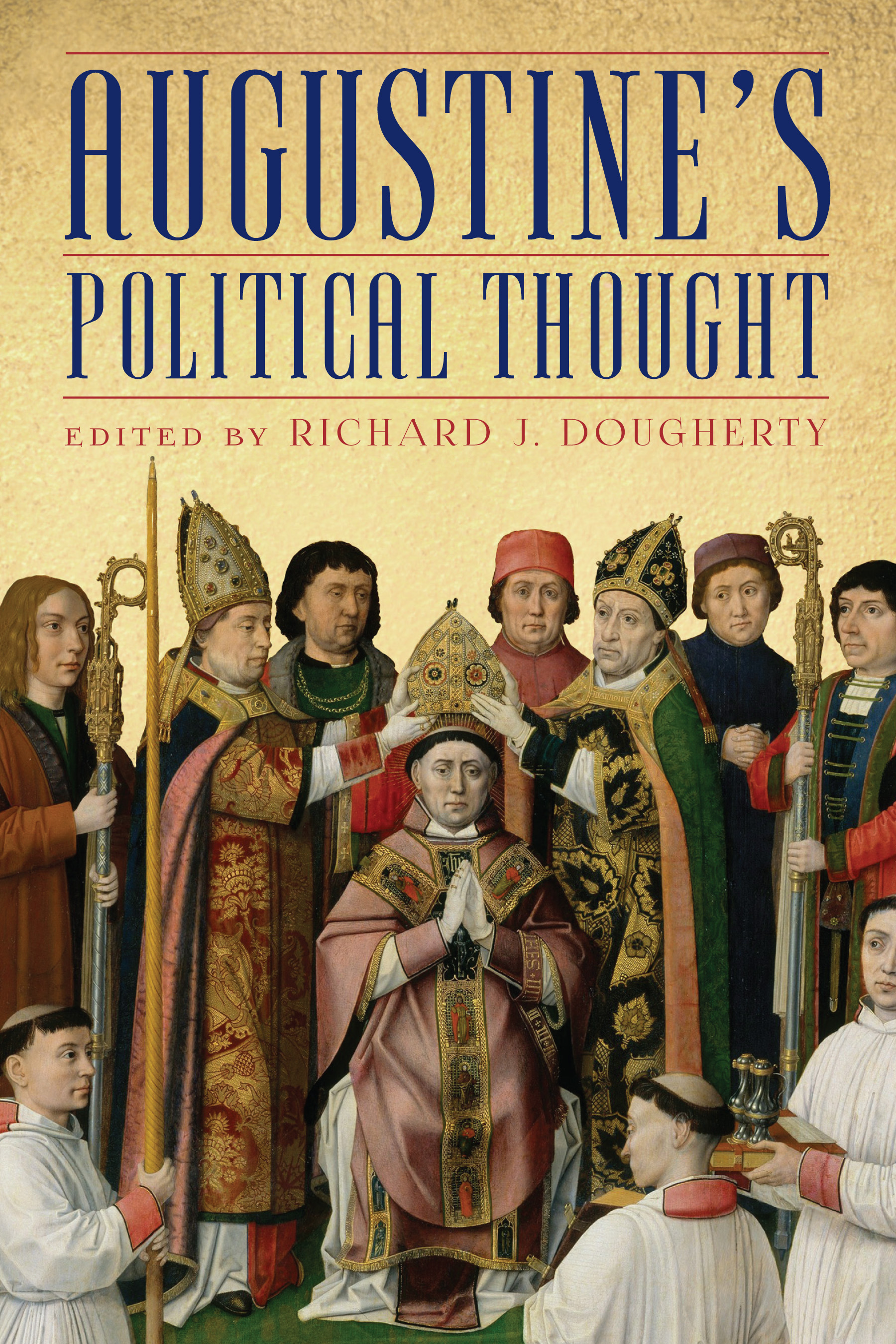
Augustine's Political Thought This important collection reveals that Augustine's political thought drew on and diverged from the classical tradition, contributing to the study of questions at the center of all Western political thought. POLITICAL SCIENCE,History & Theory
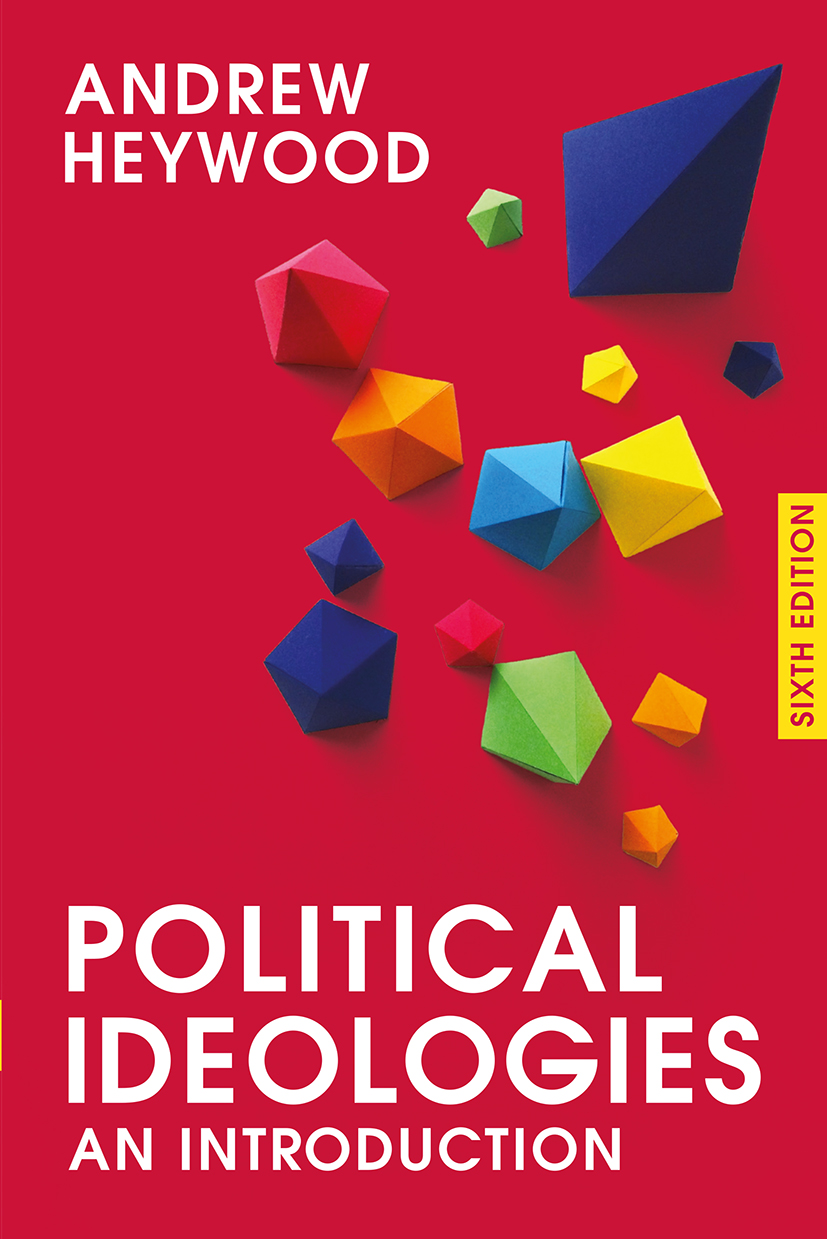
Political Ideologies The 6th edition of Andrew Heywood’s best-selling undergraduate textbook provides a clear and accessible introduction to the political creeds and doctrines that have dominated and shaped politics around the world. The author offers a clear exposition both of the historical development of each ideology and of the impact it has had on contemporary political behaviour, movements, parties and governments. In recent years, political commentators have heralded a renaissance of popular political ideology, characterised by a resurgence of issues and political traditions that many had thought obsolete. This new edition is updated throughout to take account of these developments, broadening its appeal internationally. The book is particularly relevant for first and second year undergraduate teaching, and can be used to structure a whole course on political ideologies covering traditional ideologies (conservatism, socialism, liberalism, anarchism and fascism) as well as concepts which have developed into concrete ideologies more recently (multiculturalism, feminism and ecologism, amongst others). POLITICAL SCIENCE,History & Theory

Disobey Exploring the philosophy of disobedience The world is out of joint, so much so that disobeying should be an urgent question for everyone. In this provocative essay, Frédéric Gros explores the roots of political obedience. Social conformity, economic subjection, respect for authorities, constitutional consensus? Examining the various styles of obedience provides tools to study, invent and induce new forms of civic disobedience and lyrical protest. Nothing can be taken for granted: neither supposed certainties nor social conventions, economic injustice or moral conviction. Thinking philosophically requires us never to accept truths and generalities that seem obvious. It restores a sense of political responsibility. At a time when the decisions of experts are presented as the result of icy statistics and anonymous calculations, disobeying becomes an assertion of humanity. To philosophize is to disobey. This book is a call for critical democracy and ethical resistance. POLITICAL SCIENCE,History & Theory
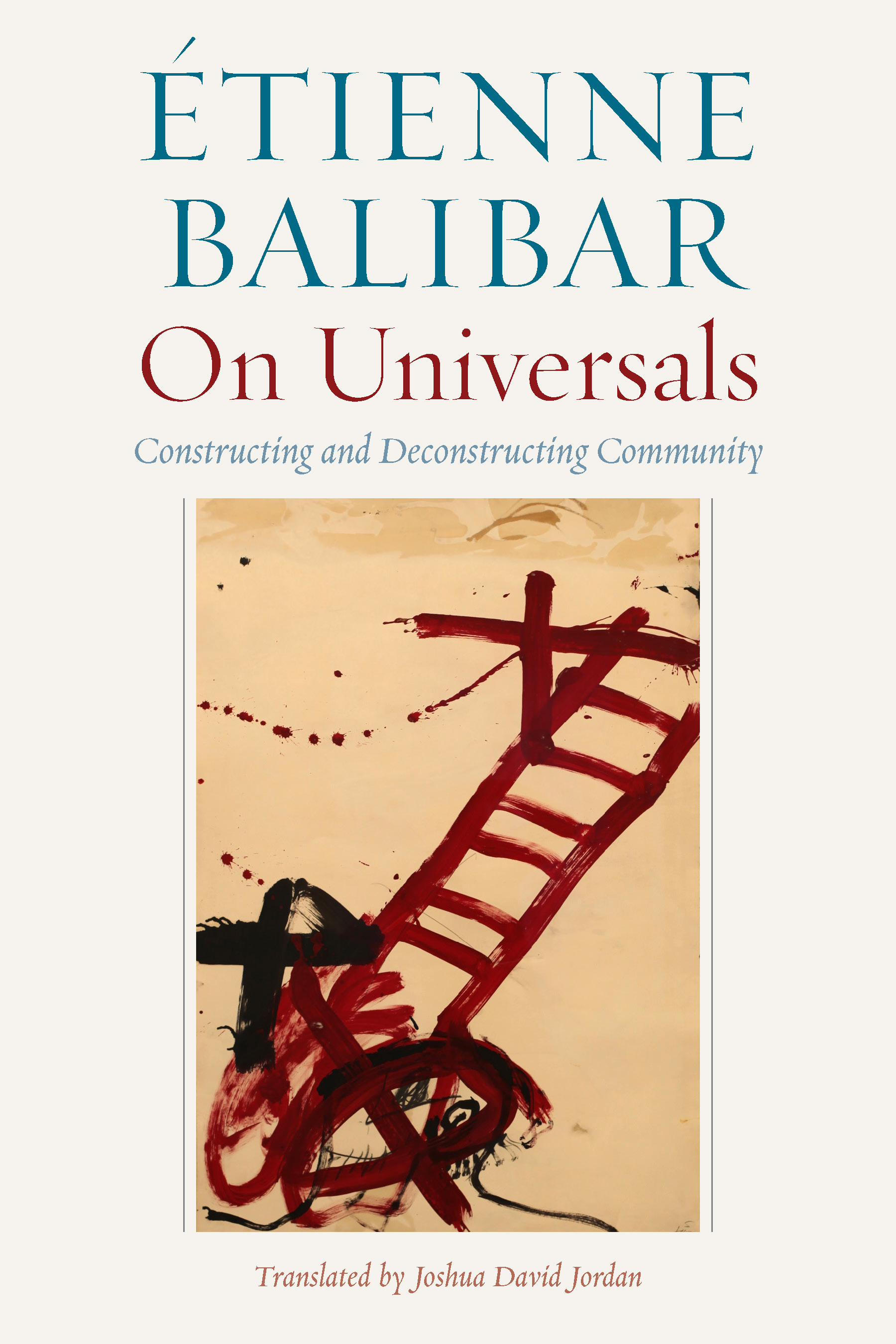
On Universals Many on the Left have looked upon “universal†as a dirty word, one that signals liberalism’s failure to recognize the masculinist and Eurocentric assumptions from which it proceeds. Balibar builds on these critiques, yet works to rescue and reinvent what universal claims can offer for a revolutionary politics answerable to the common. POLITICAL SCIENCE,History & Theory
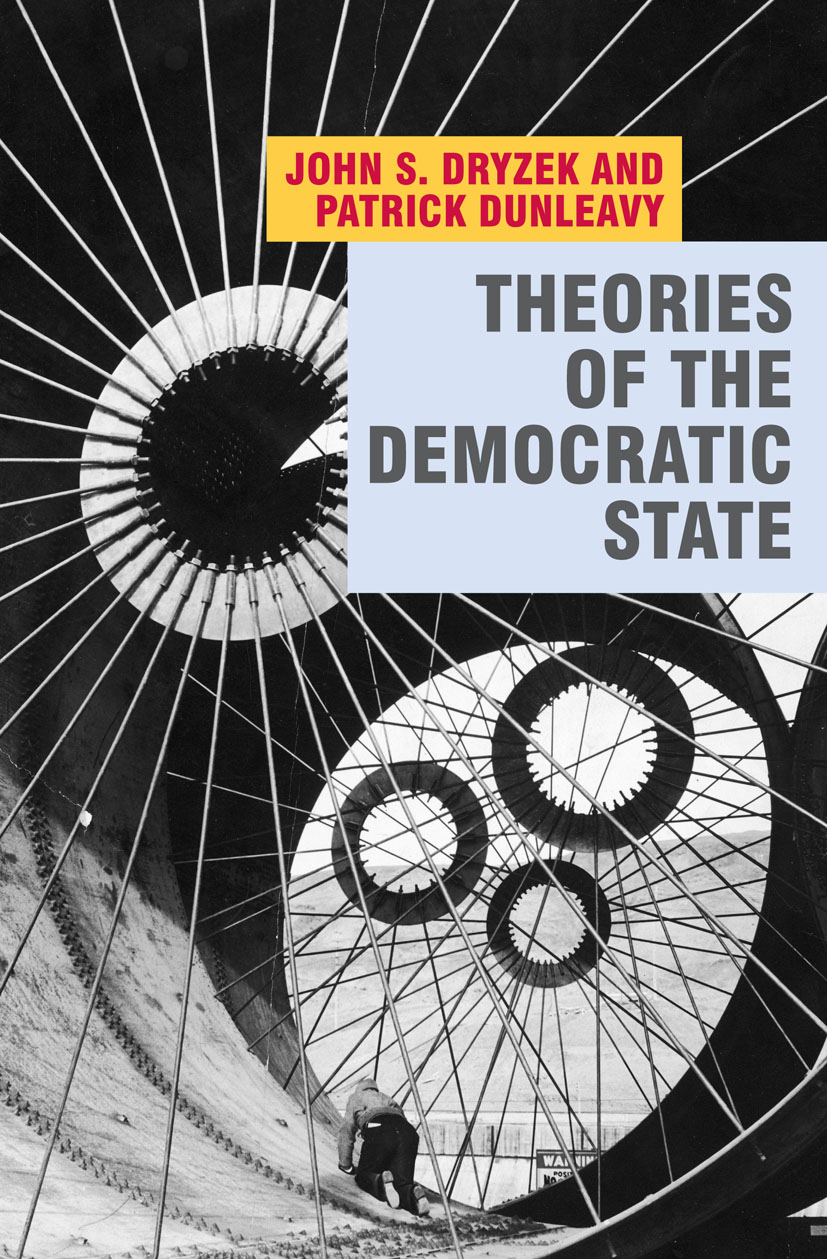
Theories of the Democratic State This major work provides a broad-ranging assessment of classical and contemporary theories of the state, focusing primarily on the democratic state. As well as outlining theories used to understand the state, it examines critiques of modern states that have emerged from feminism, environmentalism, neo-conservatism and post-modernism. POLITICAL SCIENCE,History & Theory
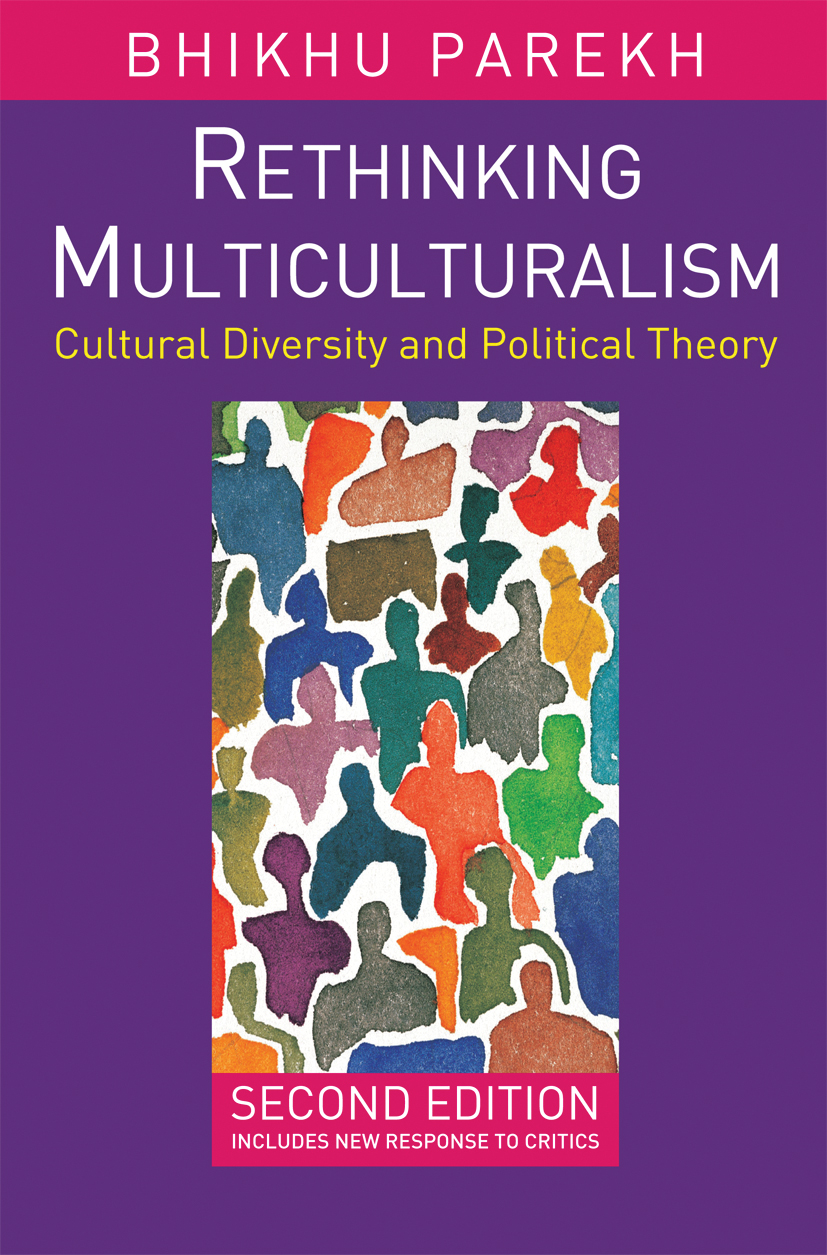
Rethinking Multiculturalism This important and much acclaimed book rapidly became a classic on first publication. In it, Bhikhu Parekh shows that the Western tradition of political philosophy has very limited theoretical resources to cope with cultural diversity. He then discusses how it can be revised and what new conceptual tools are needed. The core of the book addresses the important theoretical questions raised by contemporary multicultural society, especially the nature and limits of intercultural equality and fairness, national identity, citizenship, and cross-cultural political discourse. The new second edition includes a substantial additional chapter addressing key issues. POLITICAL SCIENCE,History & Theory
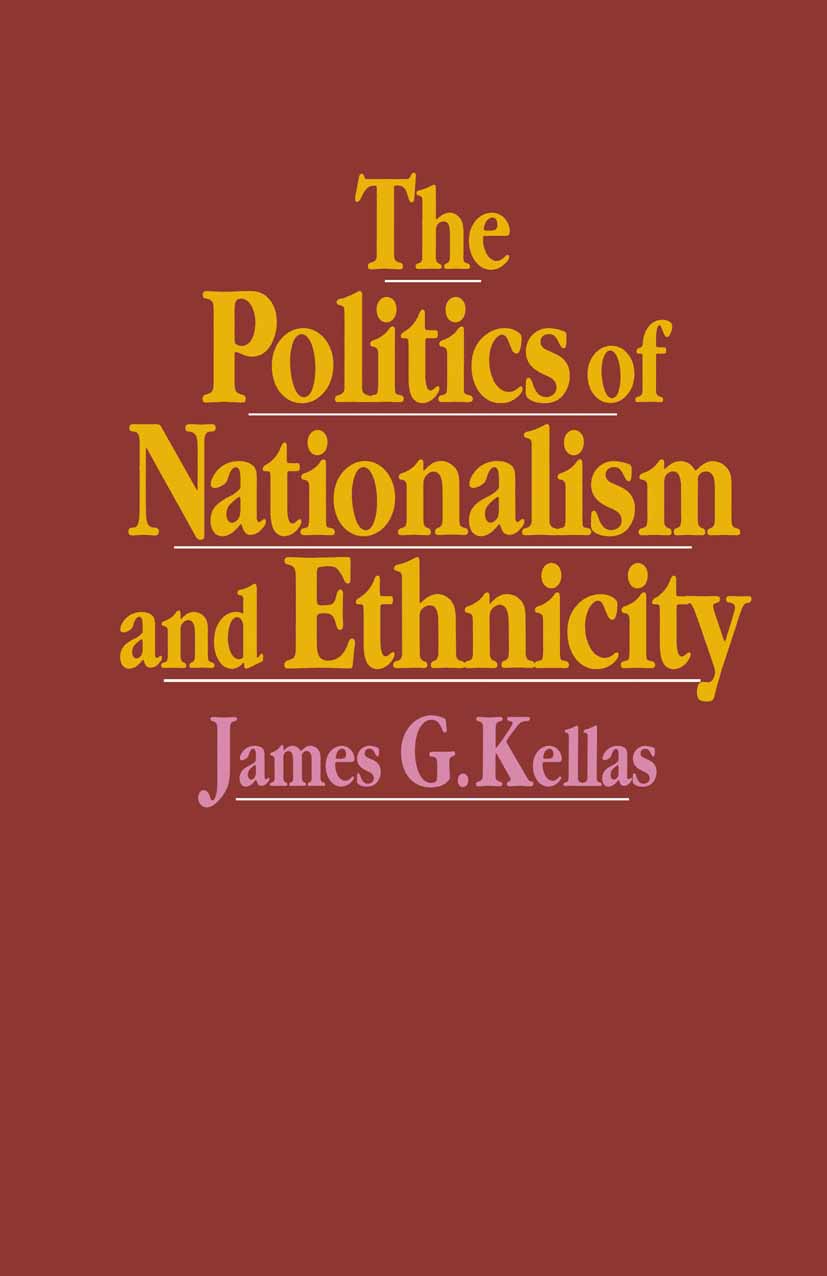
Politics of Nationalism and Ethnicity James Kellas' book provides a review of the main theoretical approaches to the study of nationalism drawn from a wide range of disciplines which he pulls together to provide an integrated framework to explain the power of nationalism and ethnicity in politics and the circumstances in which they flourish. A range of case studies from around the world assess contemporary nationalist movements and the strategies of pluralism and accommodation which have been developed to contain them. POLITICAL SCIENCE,History & Theory
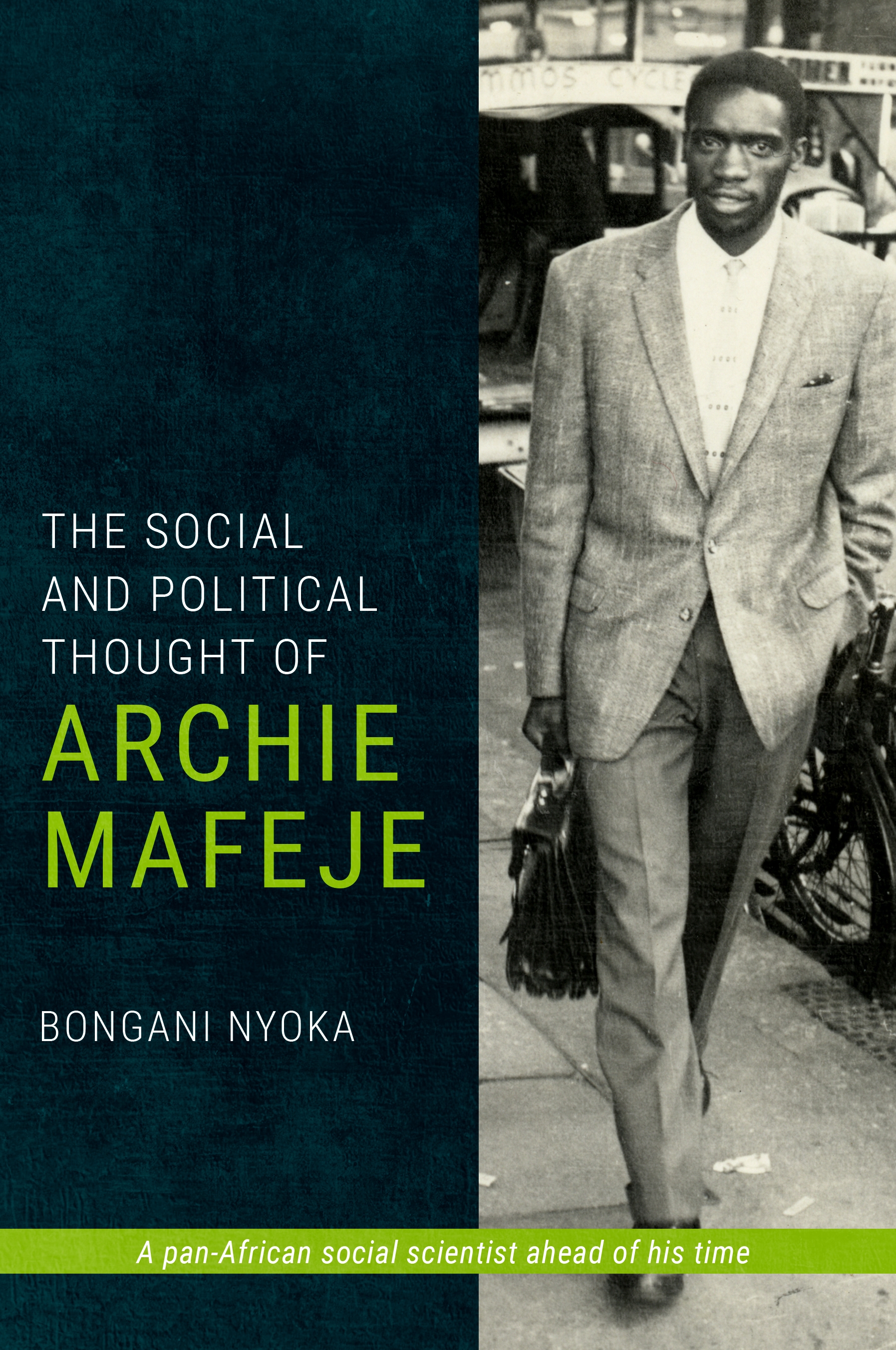
The Social and Political Thought of Archie Mafeje This comprehensive treatment of Archie Mafeje as a thinker and researcher analyses his overall scholarship and his role as a theoretician of liberation and revolutionary theory Social scientist Archie Mafeje, who was born in the Eastern Cape but lived most of his scholarly life in exile, was one of Africa's most prominent intellectuals. This ground-breaking work is the first of its kind to consider the entire body of Mafeje’s oeuvre and offers a much-needed engagement with his ideas. The most inclusive and critical treatment to date of Mafeje as a thinker and researcher, the book analyses his overall scholarship and his role as a theoretician of liberation and revolution. Author Bongani Nyoka's main argument is that Mafeje’s superb scholarship developed out of his experience as an oppressed black person and his early political education, which merged with his university training to turn him into a formidable cutting-edge intellectual force. There are three main parts to the book. Part I evaluates Mafeje's critique of the social sciences, part II focuses on his work on land and agrarian issues in sub-Saharan Africa and part III deals with his work on revolutionary theory and politics. The book engages in the act of knowledge decolonisation, making a unique contribution to South Africa’s sociological, historical and political studies. POLITICAL SCIENCE,History & Theory
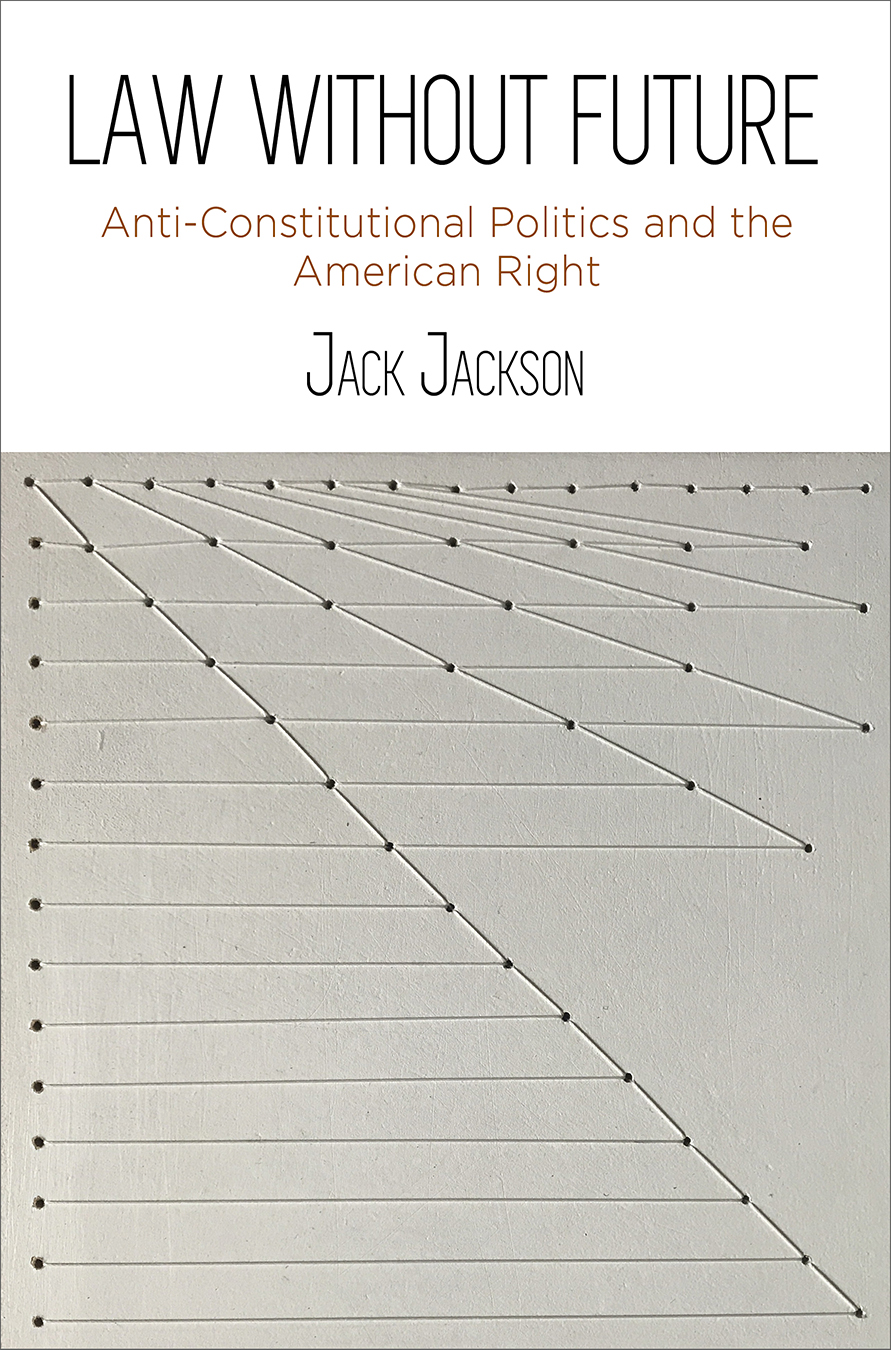
Law Without Future Drawing upon legal scholarship and critical theory, Jack Jackson explores an ascendant radical and illiberal power on the American Right and considers how it has undermined the very idea of constitutional government. POLITICAL SCIENCE,History & Theory
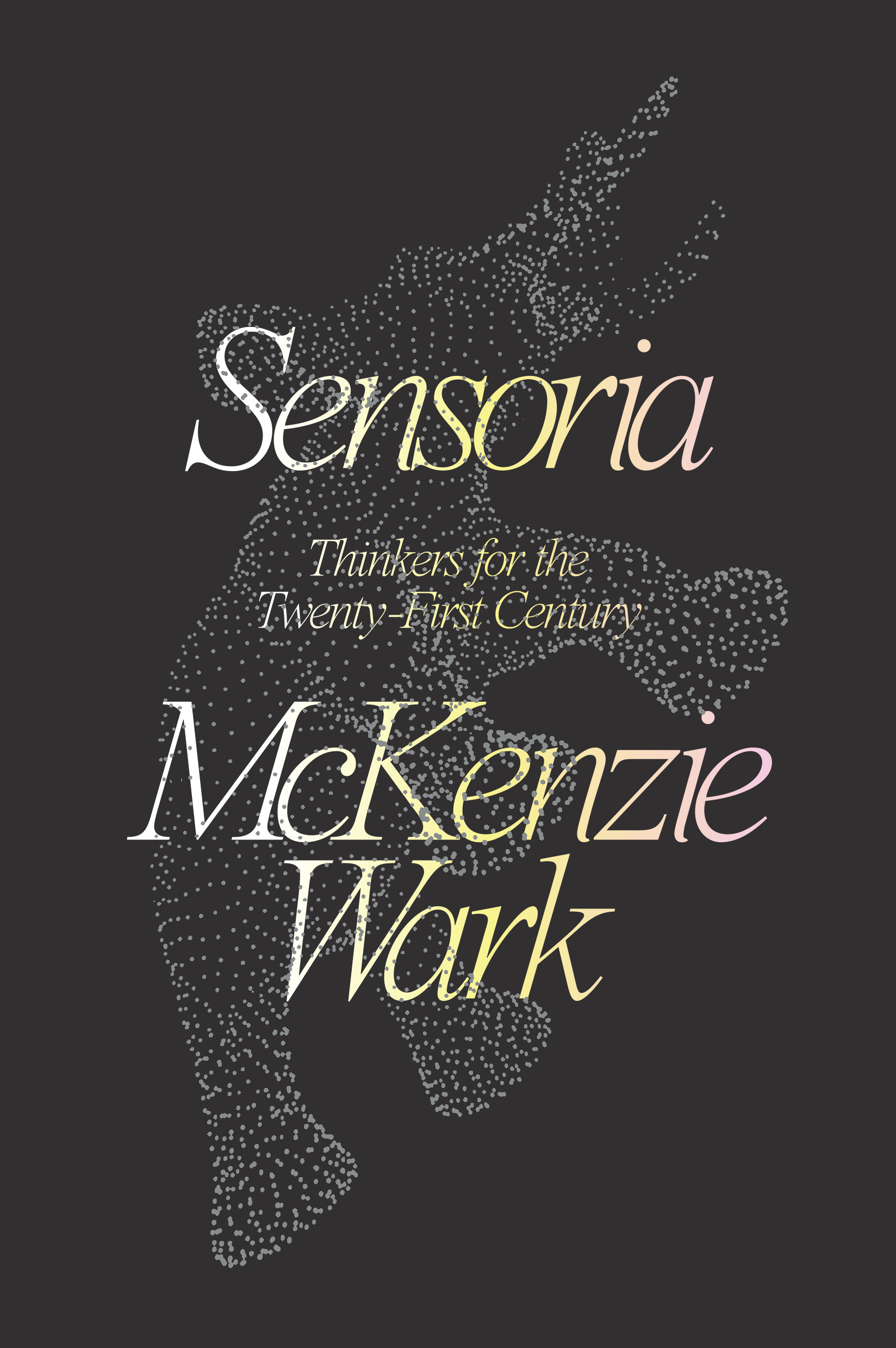
Sensoria Design, Politics, the Environment: a survey of the key thinkers and ideas that are rebuilding the world in the shadow of the anthropocene As we face the compounded crises of late capitalism, environmental catastrophe and technological transformation, who are the thinkers and the ideas who will allow us to understand the world we live in? McKenzie Wark surveys three areas at the cutting edge of current critical thinking: design, environment, technology and introduces us to the thinking of nineteen major writers. Each chapter is a concise account of an individual thinker, providing useful context and connections to the work of the others. The authors include: Sianne Ngai, Kodwo Eshun, Lisa Nakamura, Hito Steyerl, Yves Citton, Randy Martin, Jackie Wang, Anna Lowenhaupt Tsing, Achille Mbembe, Deborah Danowich and Eduardo Viveiros de Castro, Eyal Weizman, Cory Doctorow, Benjamin Bratton, Tiziana Terranova, Keller Easterling, Jussi Parikka. Wark argues that we are too often told that expertise is obtained by specialisation. Sensoria connects the themes and arguments across intellectual silos. They explore the edges of disciplines to show how we might know the world: through the study of culture, the different notions of how we create such things, and the impact that the machines that we devise have had upon us. The book is a vital and timely introduction to the future both as a warning but also as a road map on how we might find our way out of the current crisis. POLITICAL SCIENCE,History & Theory
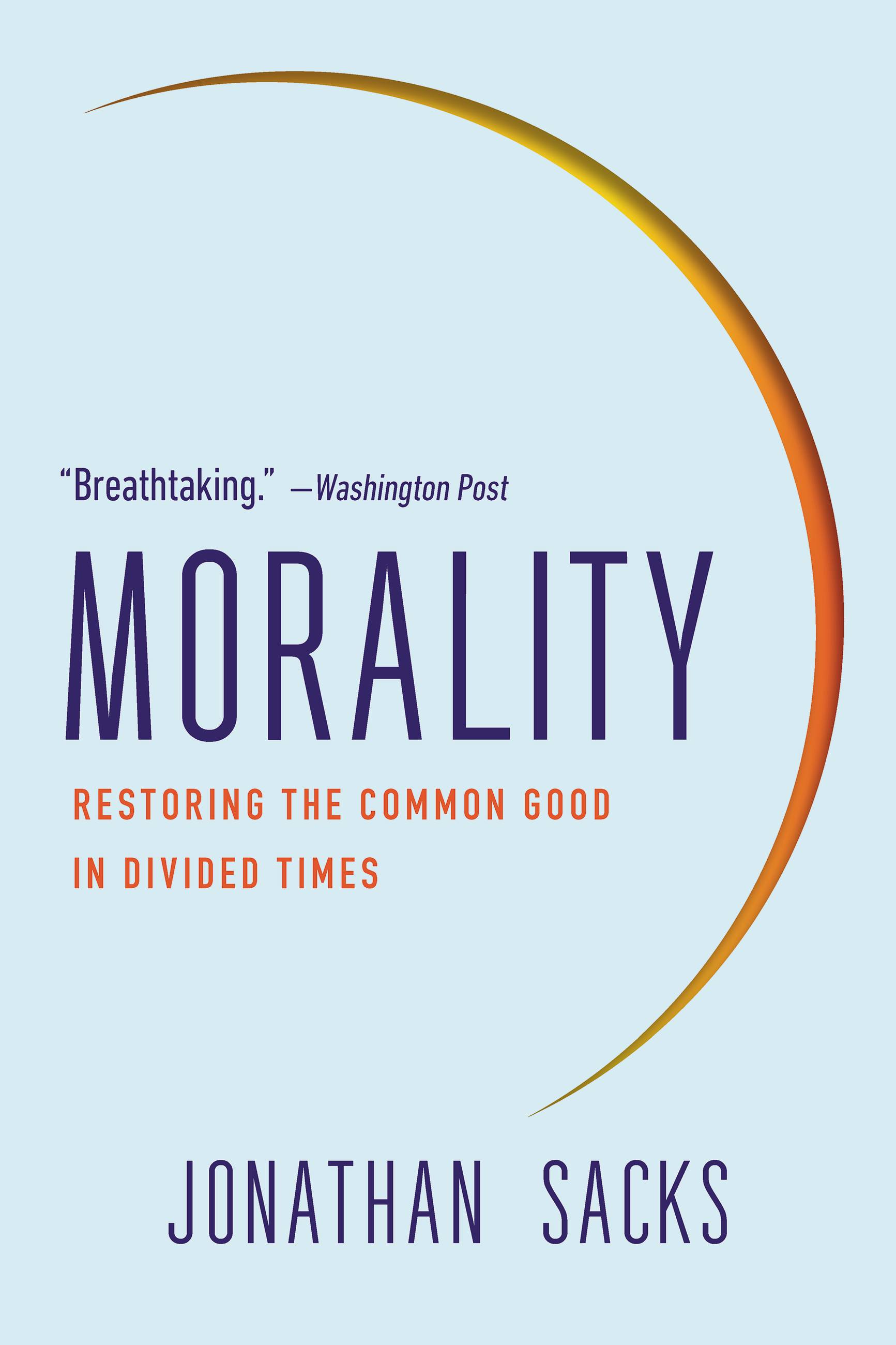
Morality A distinguished religious leader's stirring case for reconstructing a shared framework of virtues and values. With liberal democracy embattled, public discourse grown toxic, family life breaking down, and drug abuse and depression on the rise, many fear what the future holds. In Morality, respected faith leader and public intellectual Jonathan Sacks traces today's crisis to our loss of a strong, shared moral code and our elevation of self-interest over the common good. We have outsourced morality to the market and the state, but neither is capable of showing us how to live. Sacks leads readers from ancient Greece to the Enlightenment to the present day to show that there is no liberty without morality and no freedom without responsibility, arguing that we all must play our part in rebuilding a common moral foundation. A major work of moral philosophy, Morality is an inspiring vision of a world in which we can all find our place and face the future without fear. POLITICAL SCIENCE,History & Theory

Your Whole Life James Bernard Murphy challenges widely shared assumptions about personhood and its development through discrete stages, arguing they undermine our ability to see our lives as a whole. Drawing on classic and contemporary thinkers, Murphy argues that we live our whole lives as children, adolescents, and adults all at the same time. POLITICAL SCIENCE,History & Theory

Cookbook Politics From Julia Child's Mastering the Art of French Cooking to the community cookbook created by the First Baptist Church of Midland, Tennessee, Cookbook Politics explores the sensual and political implications of cookbooks, demonstrating how they create nations, establish ideologies, shape international relations, and form communities. POLITICAL SCIENCE,History & Theory
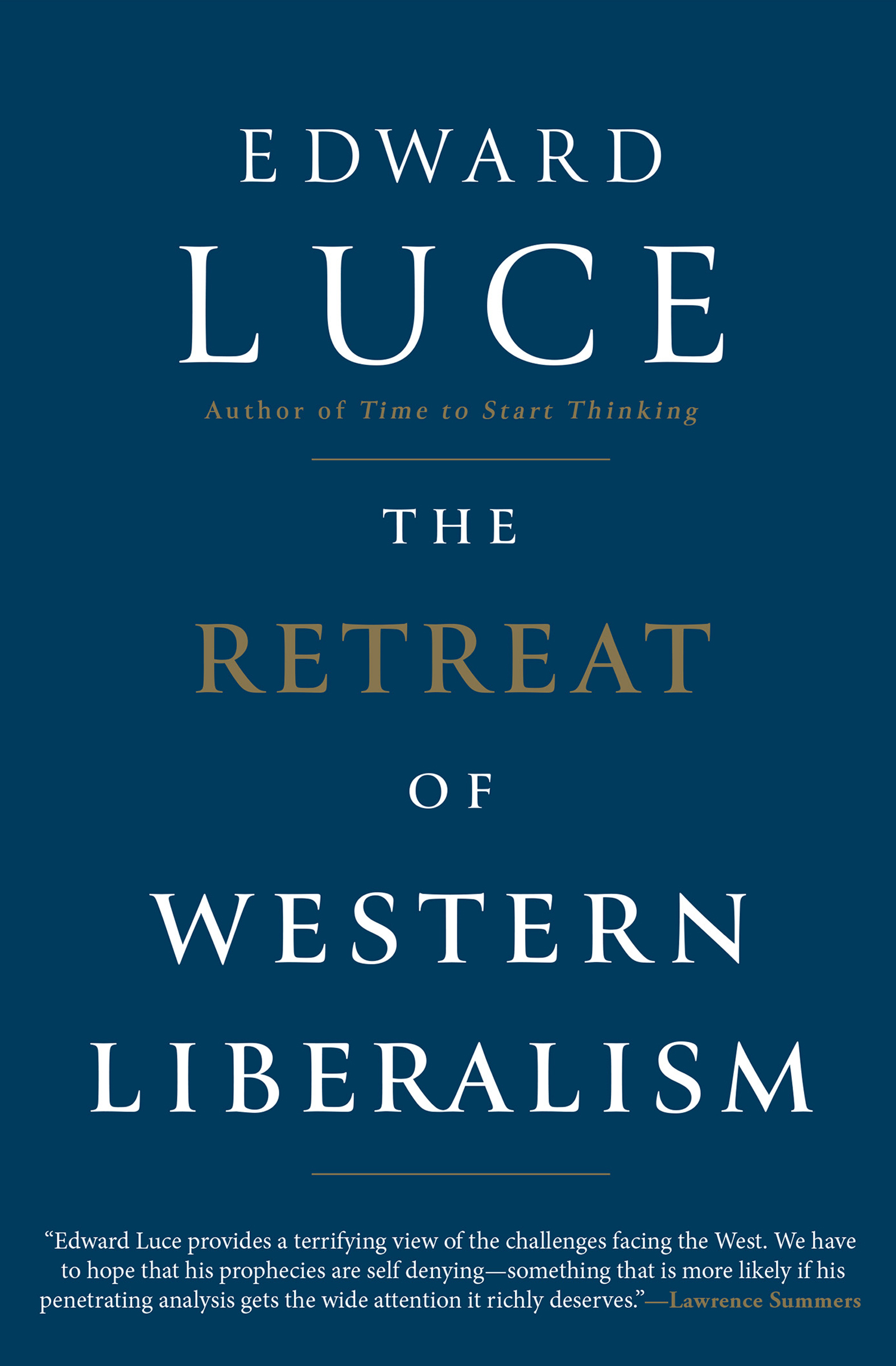
The Retreat of Western Liberalism An “insightful and harrowing†analysis of the state of Western-style democracy by the Financial Times columnist and author of Time to Start Thinking (The New York Times). In his widely acclaimed book Time to Start Thinking, Financial Times columnist Edward Luce charted the course of America’s economic and geopolitical decline, proving to be a prescient voice on the state of the nation. In The Retreat of Western Liberalism, Luce makes a larger statement about the weakening of western hegemony and the crisis of democratic liberalism—of which Donald Trump and his European counterparts are not the cause, but a symptom. Luce argues that we are on a menacing trajectory brought about by ignorance of what it took to build the West, arrogance toward society’s economic losers, and complacency about our system’s durability—attitudes that have been emerging since the fall of the Berlin Wall. Unless the West can rekindle an economy that produces gains for the majority of its people, its political liberties may be doomed. Combining on-the-ground reporting with economic analysis, Luce offers a detailed projection of the consequences of the Trump administration and a forward-thinking analysis of what those who believe in enlightenment values must do to protect them. POLITICAL SCIENCE,History & Theory

The Socratic Individual This book explores the recovery of Socratic philosophy in 19 th century political thought of G.W.F. Hegel, Soren Kierkegaard, John Stuart Mill, and Friedrich Nietzsche. For Kierkegaard the Socratic indivdual in modern times is the person of faith, for Mill the idiosyncratic public intellectual, and for Nietzsche the Dionysian artist. POLITICAL SCIENCE,History & Theory
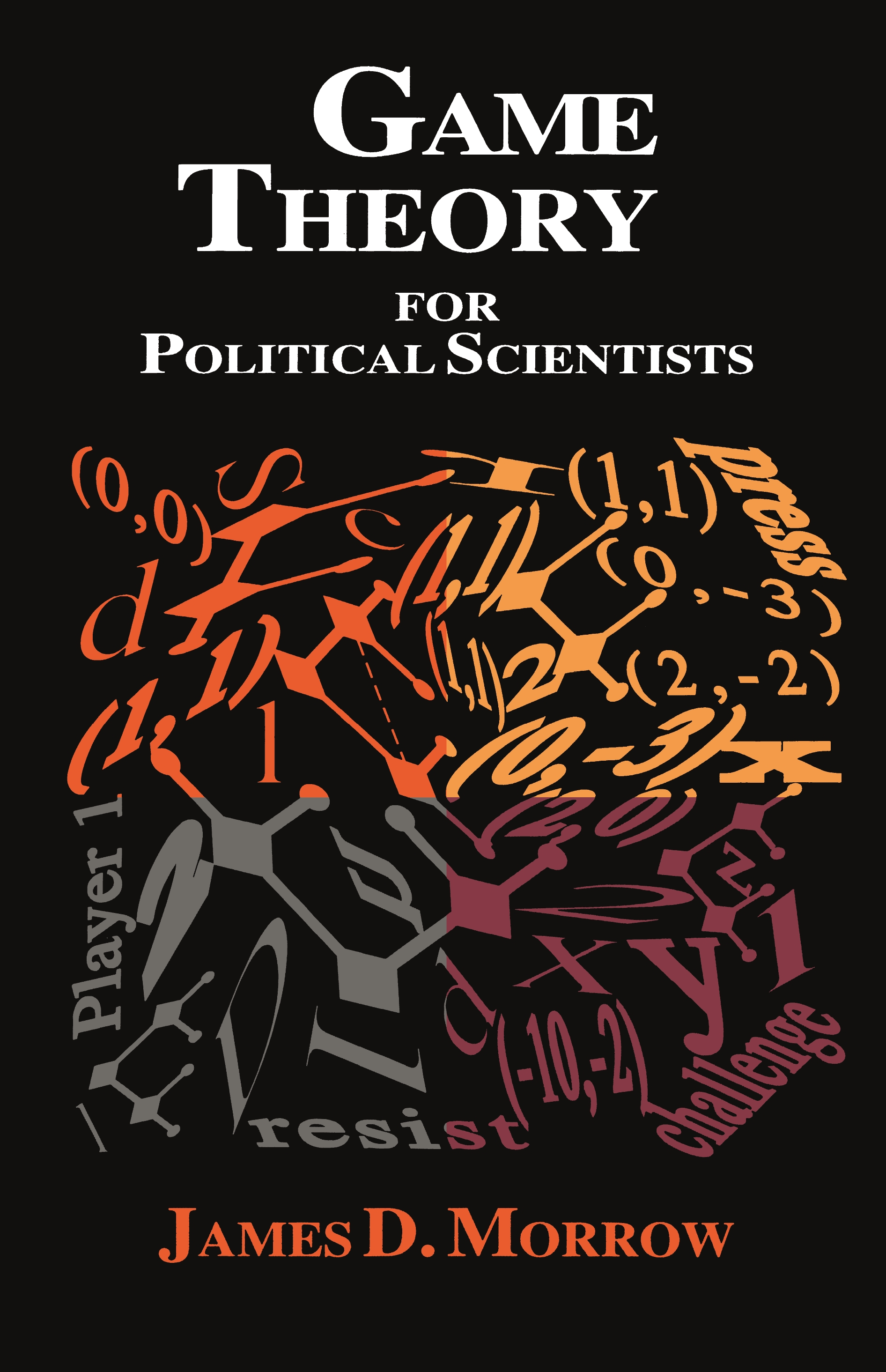
Game Theory for Political Scientists Game theory is the mathematical analysis of strategic interaction. In the fifty years since the appearance of von Neumann and Morgenstern's classic Theory of Games and Economic Behavior (Princeton, 1944), game theory has been widely applied to problems in economics. Until recently, however, its usefulness in political science has been underappreciated, in part because of the technical difficulty of the methods developed by economists. James Morrow's book is the first to provide a standard text adapting contemporary game theory to political analysis. It uses a minimum of mathematics to teach the essentials of game theory and contains problems and their solutions suitable for advanced undergraduate and graduate students in all branches of political science. Morrow begins with classical utility and game theory and ends with current research on repeated games and games of incomplete information. The book focuses on noncooperative game theory and its application to international relations, political economy, and American and comparative politics. Special attention is given to models of four topics: bargaining, legislative voting rules, voting in mass elections, and deterrence. An appendix reviews relevant mathematical techniques. Brief bibliographic essays at the end of each chapter suggest further readings, graded according to difficulty. This rigorous but accessible introduction to game theory will be of use not only to political scientists but also to psychologists, sociologists, and others in the social sciences. POLITICAL SCIENCE,History & Theory

The Sovereign State and Its Competitors The present international system, composed for the most part of sovereign, territorial states, is often viewed as the inevitable outcome of historical development. Hendrik Spruyt argues that there was nothing inevitable about the rise of the state system, however. Examining the competing institutions that arose during the decline of feudalism--among them urban leagues, independent communes, city states, and sovereign monarchies--Spruyt disposes of the familiar claim that the superior size and war-making ability of the sovereign nation-state made it the natural successor to the feudal system. The author argues that feudalism did not give way to any single successor institution in simple linear fashion. Instead, individuals created a variety of institutional forms, such as the sovereign, territorial state in France, the Hanseatic League, and the Italian city-states, in reaction to a dramatic change in the medieval economic environment. Only in a subsequent selective phase of institutional evolution did sovereign, territorial authority prove to have significant institutional advantages over its rivals. Sovereign authority proved to be more successful in organizing domestic society and structuring external affairs. Spruyt's interdisciplinary approach not only has important implications for change in the state system in our time, but also presents a novel analysis of the general dynamics of institutional change. POLITICAL SCIENCE,History & Theory
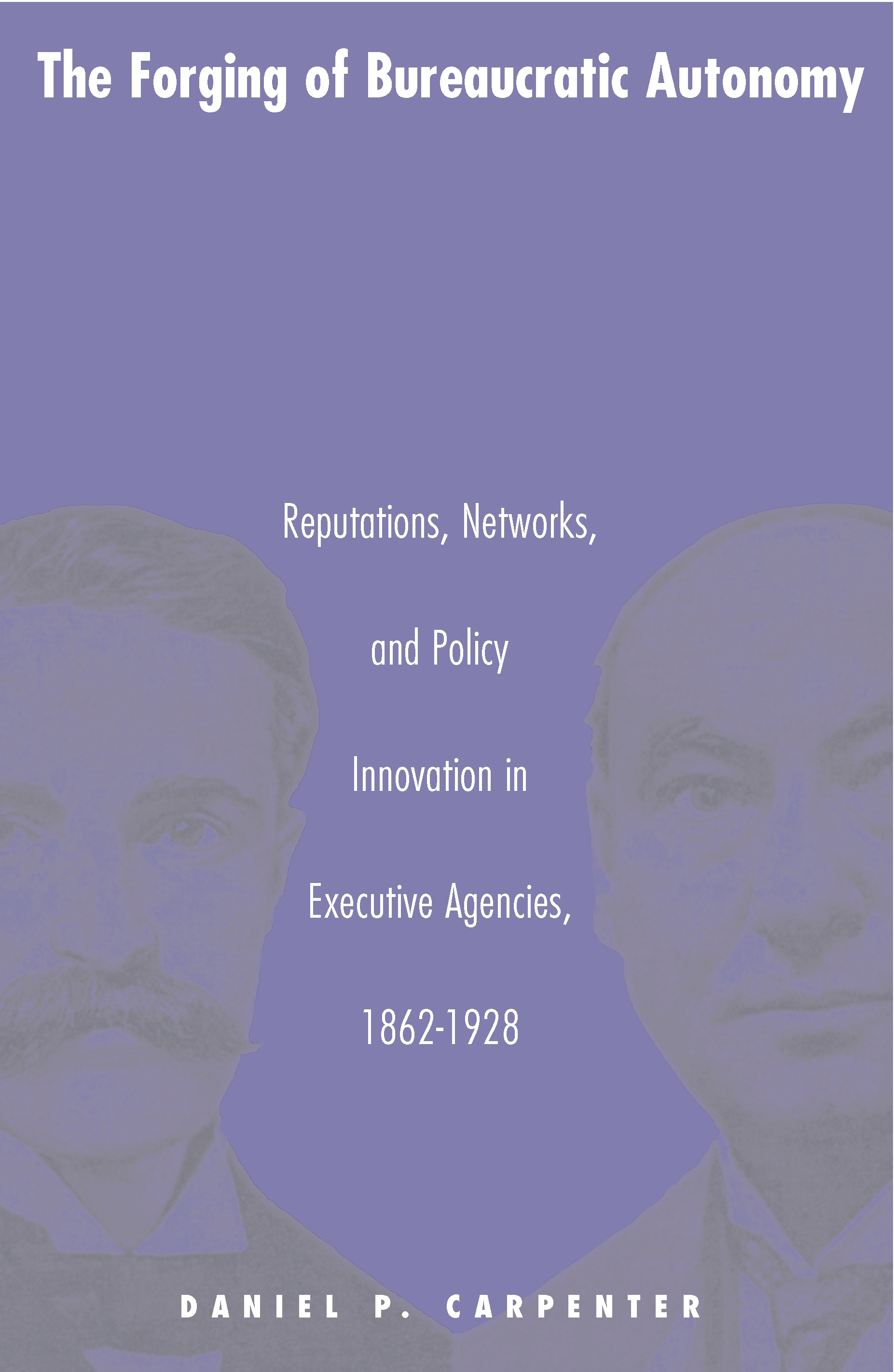
The Forging of Bureaucratic Autonomy Until now political scientists have devoted little attention to the origins of American bureaucracy and the relationship between bureaucratic and interest group politics. In this pioneering book, Daniel Carpenter contributes to our understanding of institutions by presenting a unified study of bureaucratic autonomy in democratic regimes. He focuses on the emergence of bureaucratic policy innovation in the United States during the Progressive Era, asking why the Post Office Department and the Department of Agriculture became politically independent authors of new policy and why the Interior Department did not. To explain these developments, Carpenter offers a new theory of bureaucratic autonomy grounded in organization theory, rational choice models, and network concepts. According to the author, bureaucracies with unique goals achieve autonomy when their middle-level officials establish reputations among diverse coalitions for effectively providing unique services. These coalitions enable agencies to resist political control and make it costly for politicians to ignore the agencies' ideas. Carpenter assesses his argument through a highly innovative combination of historical narratives, statistical analyses, counterfactuals, and carefully structured policy comparisons. Along the way, he reinterprets the rise of national food and drug regulation, Comstockery and the Progressive anti-vice movement, the emergence of American conservation policy, the ascent of the farm lobby, the creation of postal savings banks and free rural mail delivery, and even the congressional Cannon Revolt of 1910. POLITICAL SCIENCE,History & Theory
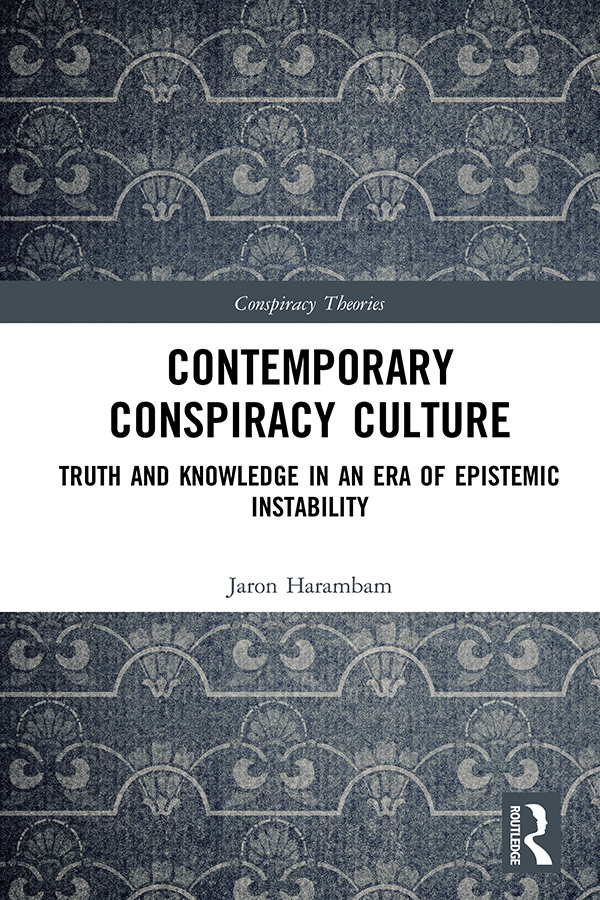
Contemporary Conspiracy Culture In this ethnographic study, the author takes an agnostic stance towards the truth value of conspiracy theories and delves into the everyday lives of people active in the conspiracy milieu to understand better what the contemporary appeal of conspiracy theories is. Conspiracy theories have become popular cultural products, endorsed and shared by significant segments of Western societies. Yet our understanding of who these people are and why they are attracted by these alternative explanations of reality is hampered by their implicit and explicit pathologization. Drawing on a wide variety of empirical sources, this book shows in rich detail what conspiracy theories are about, which people are involved, how they see themselves, and what they practically do with these ideas in their everyday lives. The author inductively develops from these concrete descriptions more general theorizations of how to understand this burgeoning subculture. He concludes by situating conspiracy culture in an age of epistemic instability where societal conflicts over knowledge abound, and the Truth is no longer assured, but "out there" for us to grapple with. This book will be an important source for students and scholars from a range of disciplines interested in the depth and complexity of conspiracy culture, including Anthropology, Cultural Studies, Communication Studies, Ethnology, Folklore Studies, History, Media Studies, Political Science, Psychology and Sociology. More broadly, this study speaks to contemporary (public) debates about truth and knowledge in a supposedly post-truth era, including widespread popular distrusts towards elites, mainstream institutions and their knowledge. POLITICAL SCIENCE,History & Theory
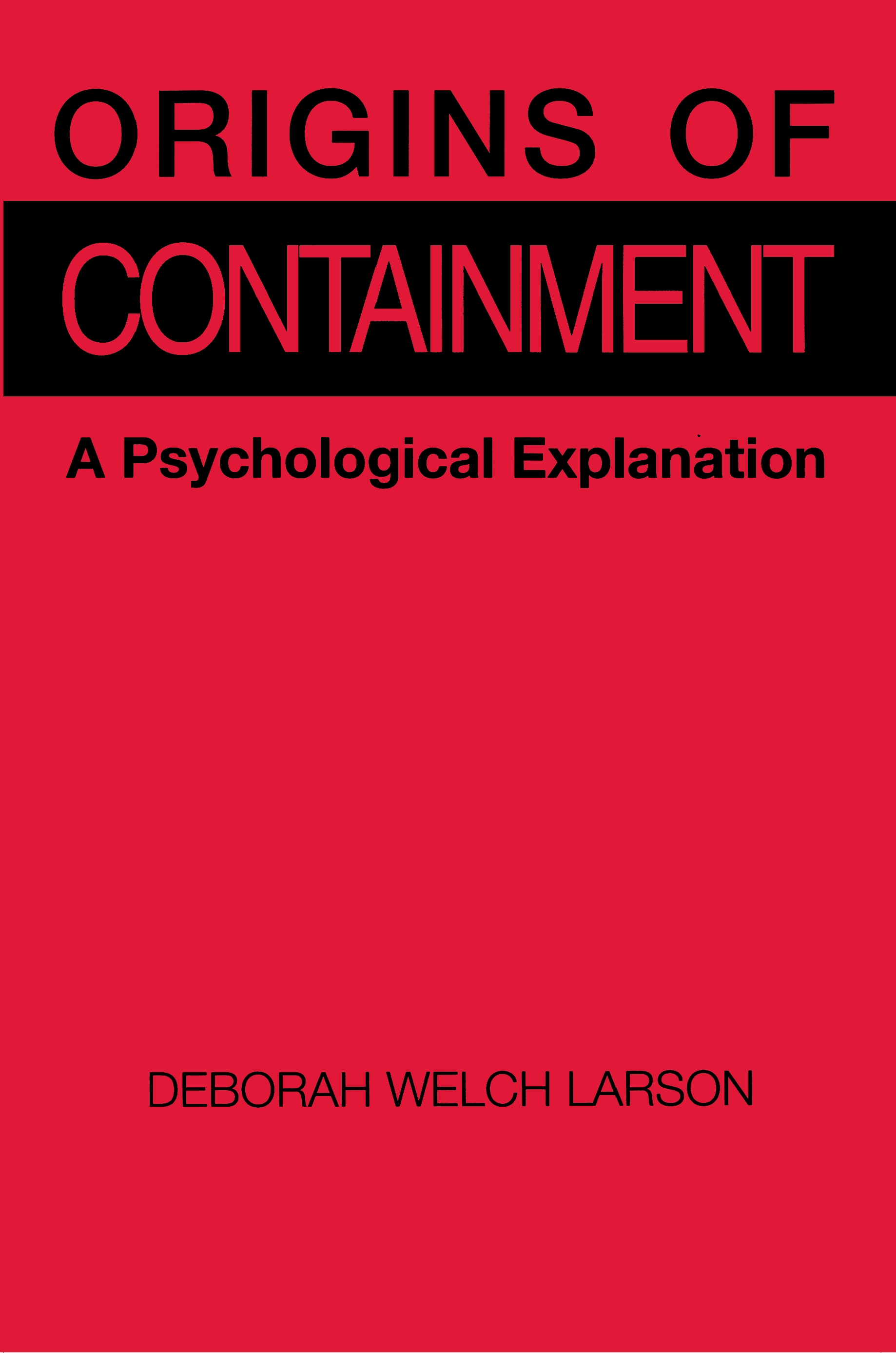
Origins of Containment The description for this book, Origins of Containment: A Psychological Explanation, will be forthcoming. POLITICAL SCIENCE,History & Theory
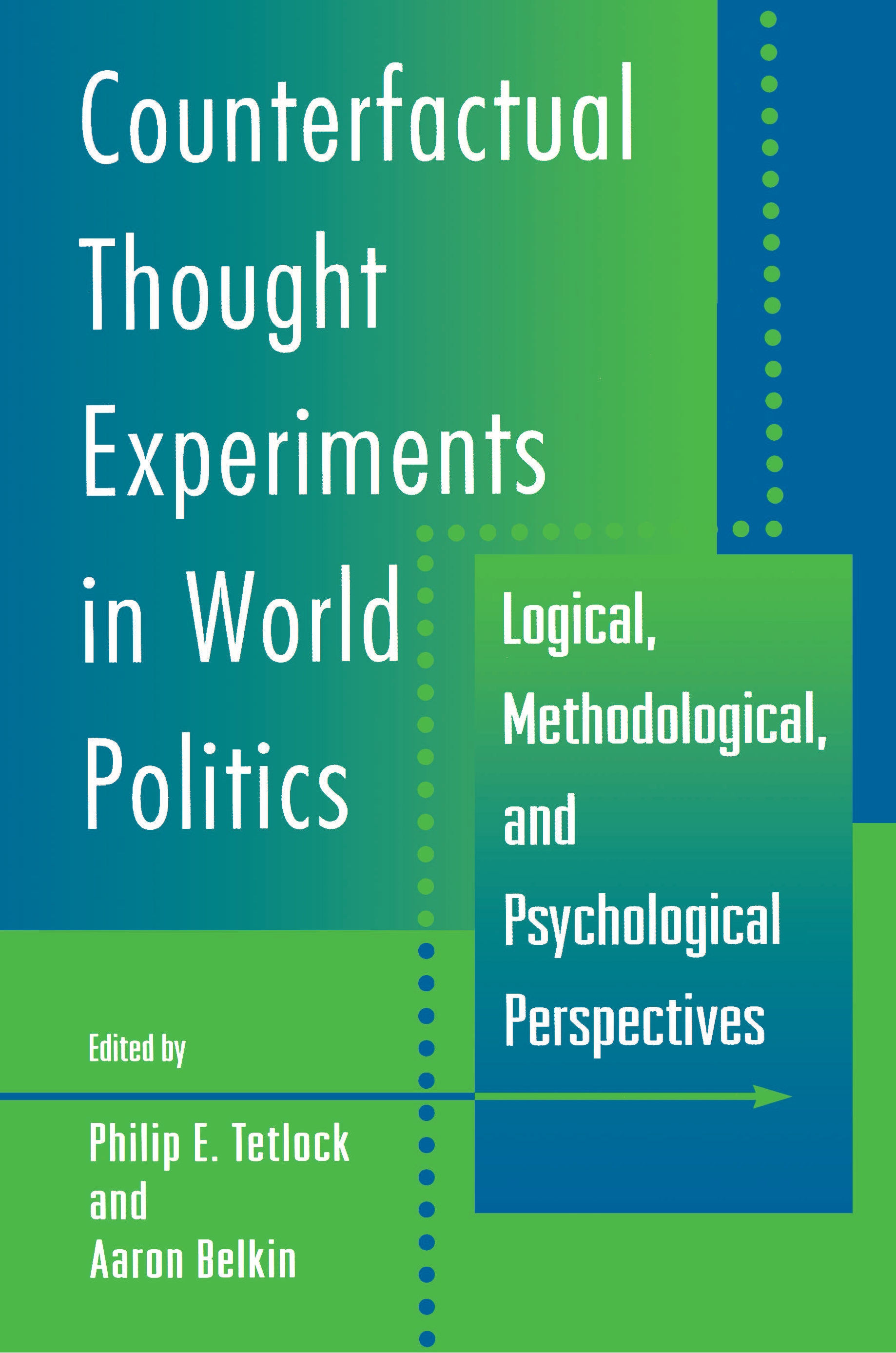
Counterfactual Thought Experiments in World Politics Political scientists often ask themselves what might have been if history had unfolded differently: if Stalin had been ousted as General Party Secretary or if the United States had not dropped the bomb on Japan. Although scholars sometimes scoff at applying hypothetical reasoning to world politics, the contributors to this volume--including James Fearon, Richard Lebow, Margaret Levi, Bruce Russett, and Barry Weingast--find such counterfactual conjectures not only useful, but necessary for drawing causal inferences from historical data. Given the importance of counterfactuals, it is perhaps surprising that we lack standards for evaluating them. To fill this gap, Philip Tetlock and Aaron Belkin propose a set of criteria for distinguishing plausible from implausible counterfactual conjectures across a wide range of applications. The contributors to this volume make use of these and other criteria to evaluate counterfactuals that emerge in diverse methodological contexts including comparative case studies, game theory, and statistical analysis. Taken together, these essays go a long way toward establishing a more nuanced and rigorous framework for assessing counterfactual arguments about world politics in particular and about the social sciences more broadly. POLITICAL SCIENCE,History & Theory

The Care Manifesto We are in the midst of a global crisis of care. How do we get out of it? The Care Manifesto puts care at the heart of the debates of our current crisis: from intimate care--childcare, healthcare, elder care--to care for the natural world. We live in a world where carelessness reigns, but it does not have to be this way. The Care Manifesto puts forth a vision for a truly caring world. The authors want to reimagine the role of care in our everyday lives, making it the organising principle in every dimension and at every scale of life. We are all dependent on each other, and only by nurturing these interdependencies can we cultivate a world in which each and every one of us can not only live but thrive. The Care Manifesto demands that we must put care at the heart of the state and the economy. A caring government must promote collective joy, not the satisfaction of individual desire. This means the transformation of how we organise work through co-operatives, localism and nationalisation. It proposes the expansion of our understanding of kinship for a more 'promiscuous care'. It calls for caring places through the reclamation of public space, to make a more convivial city. It sets out an agenda for the environment, most urgent of all, putting care at the centre of our relationship to the natural world. POLITICAL SCIENCE,History & Theory

Globalization and Liberalism In this learned and wide-ranging book, Trevor Shelley engages the controversial topic of globalization through philosophical exegesis of great texts. Globalization and Liberalism illustrates and defends the idea that at the heart of the human world is the antinomy of the universal and the particular. Various thinkers have emphasized one aspect of this tension over the other. Some, such as Rousseau and Schmitt, have defended pure particularity. Others, such as Habermas, have uncritically welcomed the intimations of the world state. Against these twin extremes of radical nationalism and antipolitical universalism, this book seeks to recover a middle or moderate position—the liberal position. To find this via media, Shelley traces a tradition of French liberal political thinkers who take account of both sides of the antinomy: Montesquieu, Tocqueville, and Manent. As Shelley argues, each of these thinkers defends the integrity of political bodies, denies that the universal perspective is the only legitimate perspective, and recognizes that, without differences and distinctions across the political landscape, self-government and freedom of action are impossible. As human beings, we can live free and fulfilling lives neither as isolated individuals nor as members of humanity. Rather, we require a properly constituted particular political community in which we can make manifest our universal humanity. In the liberalism of these three thinkers, we find the resources to think through what such a political community might look like. Globalism and Liberalism demonstrates the importance of these writers for addressing today’s challenges and will interest political theorists, historians of political thought, and specialists of French political thought. POLITICAL SCIENCE,History & Theory

Classics of American Political and Constitutional Thought, Volume 1 From James I's Address Before Parliament (1610) to Joseph R. Biden, Jr.'s Learned Hand Dinner Address Before the American Jewish Committee (2005), this two-volume set offers an unparalleled selection of key texts from the history of American political and constitutional thought. POLITICAL SCIENCE,History & Theory

The Secret Coalition The politics of the 1950s revolved around two primary leaders, one Republican and one Democratboth moderate, and both willing to compromise to move the nation forward. The Republican leader was President Dwight Eisenhower. His two administrations changed American politics. Ike’s desire to be president of all the people, to run his administration down the middle of the road, to be a modern†Republican, set the stage for what the Republican Party would be for decades to come. His politics of moderation triggered a backlash from the party’s right wing that eventually grew into a conservative surge that reached fruition in the following decades. Standing astride the opposition was the Democratic leader in the Senate, Lyndon Johnson. At age 44, Johnson was the youngest leader in Senate history. His willingness to join forces with Eisenhower in the president’s battles against isolationism and reaction in his own party, along with the willingness of both men to compromise rather than engage in a politics of search and destroy, turned the 1950s into an era of political moderation. In The Secret Coalition, Gary A. Donaldson insightfully explores a period in U.S. history that many Americans regard as an Era of Good Feelingâ€when the two parties got along, and the nation achieved some sort of equilibrium and cooperation. POLITICAL SCIENCE,History & Theory

Letters to America Letters to America was written to energize Americans at a time of economic stress and self-doubt. By reading of the sacrifices the previous American generations – that often endured everyday hardships beyond the comprehension of those of us with running water – challenges confronting individual modern Americans pale in comparison.Starvation and hardship was a given for the early settlers, and yet somehow they persevered and through the fruits of their labors and the tenacity of subsequent immigrants and their descendants, the United States of America grew and flourished. Do we have the work ethic and perseverance today of our forefathers? Do modern Americans even know what true suffering is? Tom Blair believes that Americans can come together to solve this country’s problems, but they will need to be able to sacrifice and work like those who have come before us.A blending of Forrest Gump, Roots and a Profiles in Courage populated by characters from the country’s past. Letters to America is a compilation of twelve letters, each a chapter told in first person, by fictional Americans about their everyday lives. The voices are entirely distinct—men, women, and children; white, black, Native American, Jewish—spanning four centuries, from early American settlers in Jamestown in the 1620s to modern day corporate lunches in mid-town Manhattan. Yet the stories are loosely linked by subtle resonances; and the letters have a cumulative effect that is both humbling and deeply affecting, filled with hope for a future that can be as inspirational as our past. POLITICAL SCIENCE,History & Theory
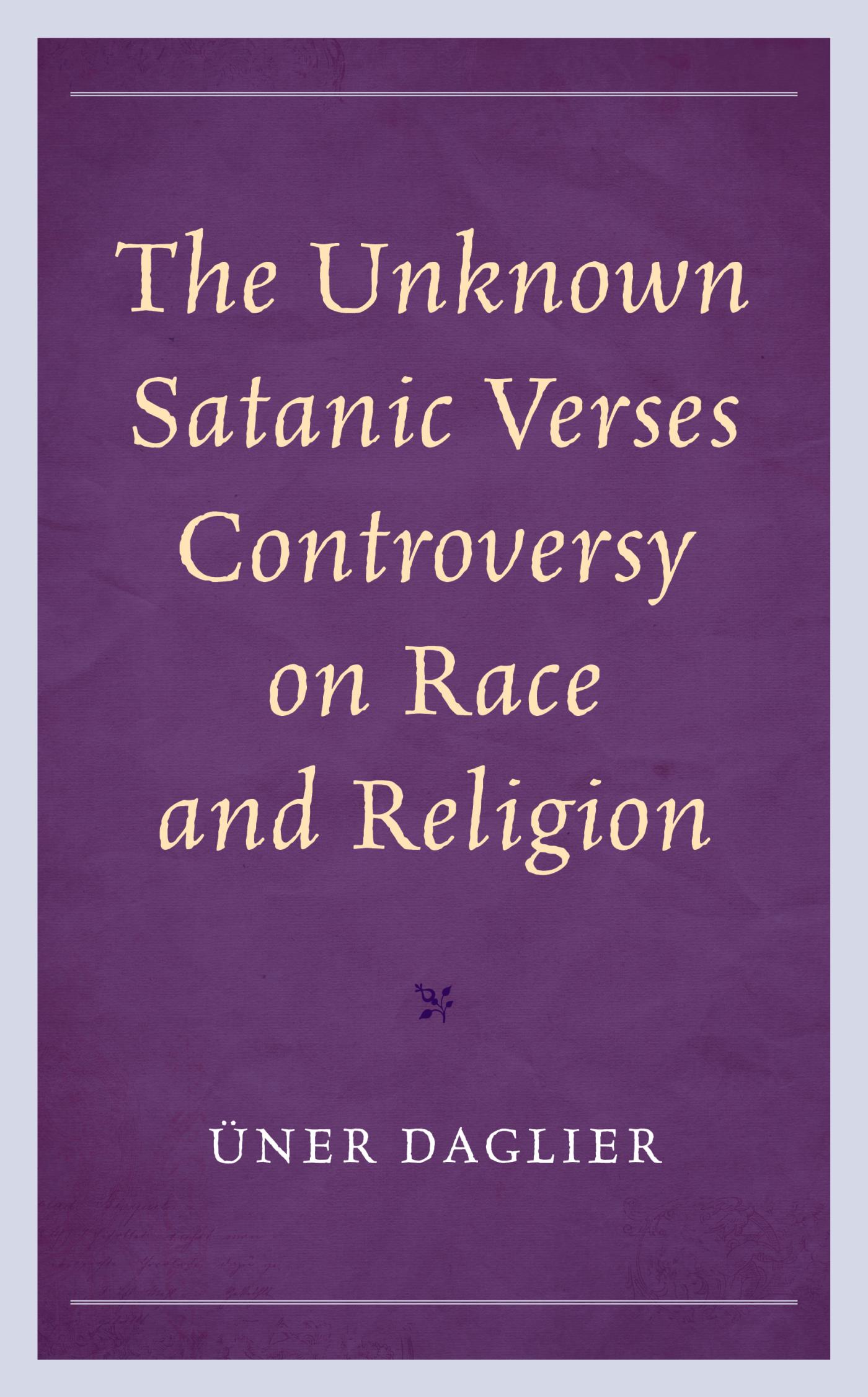
The Unknown Satanic Verses Controversy on Race and Religion Decades after its publication, Salman Rushdie’s controversial novel The Satanic Verses remains much talked about and little understood. The Unknown Satanic Verses Controversy on Race and Religion now responds to this critical gap through painstakingly detailed attention to the totality of Rushdie’s text. POLITICAL SCIENCE,History & Theory
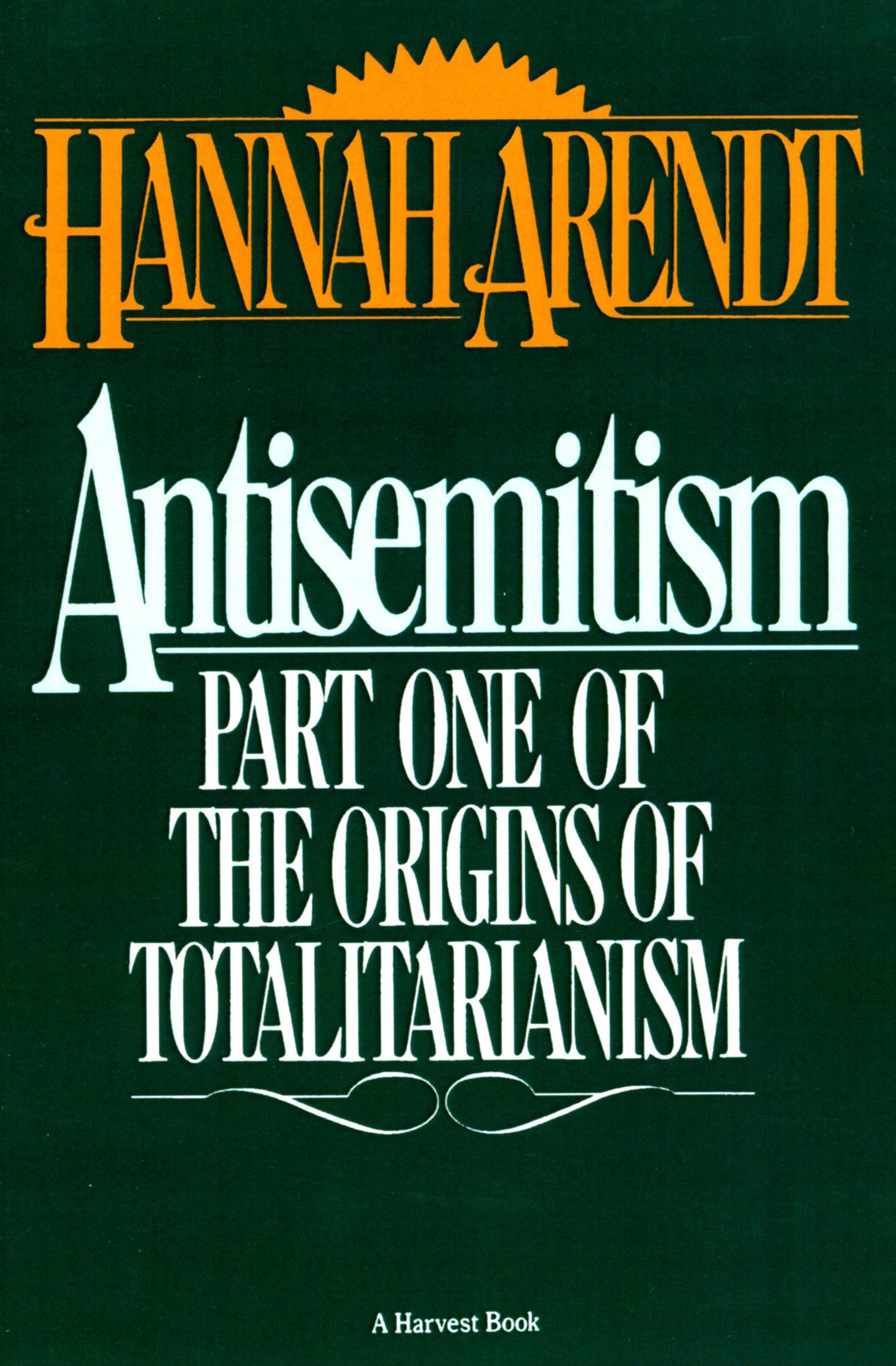
Antisemitism In the first volume of her landmark philosophical work, The Origins of Totalitarianism, the political theorist traces the rise of antisemitism in Europe. Since it was first published in 1951, The Origins of Totalitarianism has been recognized as the definitive philosophical account of the totalitarian mindset. A probing analysis of Nazism, Stalinism, and the “banality of evilâ€, it remains one of the most referenced works in studies and discussions of totalitarian movements around the world. In this first volume, Antisemitism, Dr. Hannah Arendt traces the rise of antisemitism to Central and Western European Jewish history during the 19th century. With the appearance of the first political activity by antisemitic parties in the 1870s and 1880s, Arendt states, the machinery that led to the horrors of the Holocaust was set in motion. The Dreyfus Affair, in Arendt’s view, was “a kind of dress rehearsalâ€â€”the first modern use of antisemitism as an instrument of public policy and of hysteria as a political weapon. “The most original and profound—therefore the most valuable—political theorist of our times.â€â€”Dwight MacDonald, The New Leader POLITICAL SCIENCE,History & Theory
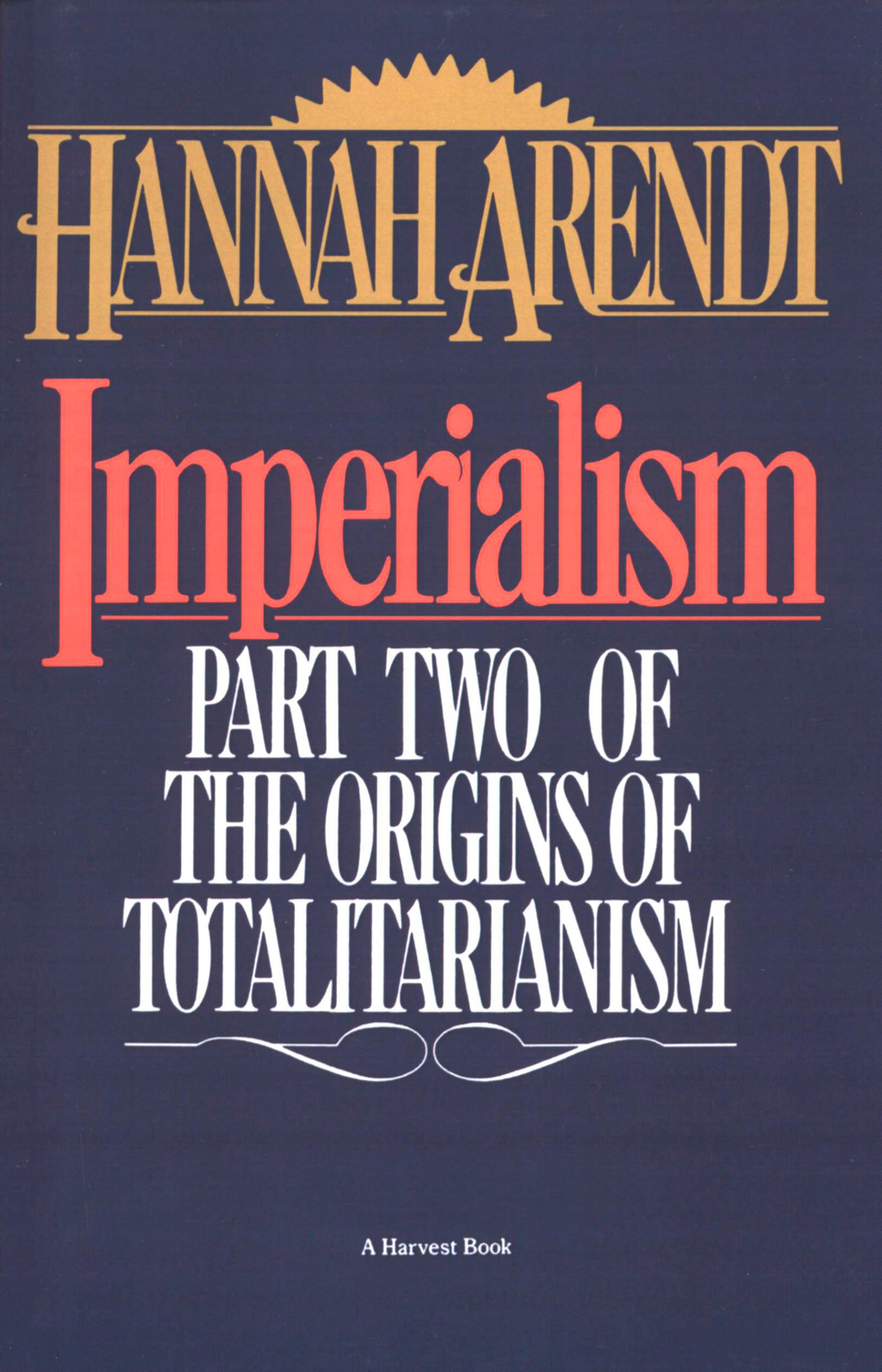
Imperialism In the second volume of The Origins of Totalitarianism, the political theorist traces the decline of European colonialism and the outbreak of WWI. Since it was first published in 1951, The Origins of Totalitarianism has been recognized as the definitive philosophical account of the totalitarian mindset. A probing analysis of Nazism, Stalinism, and the “banality of evilâ€, it remains one of the most referenced works in studies and discussions of totalitarian movements around the world. In this second volume, Imperialism, Dr. Hannah Arendt examines the cruel epoch of declining European colonial imperialism from 1884 to the outbreak of the First World War. Through portraits of Disraili, Cecil Rhodes, Gobineau, Proust, and T.E. Lawrence, Arendt illustrates how this era ended with the decline of the nation-state and the disintegration of Europe’s class society. These two events, Arendt argues, generated totalitarianism, which in turn produced the Holocaust. “The most original and profound—therefore the most valuable—political theorist of our times.â€â€”Dwight MacDonald, The New Leader POLITICAL SCIENCE,History & Theory
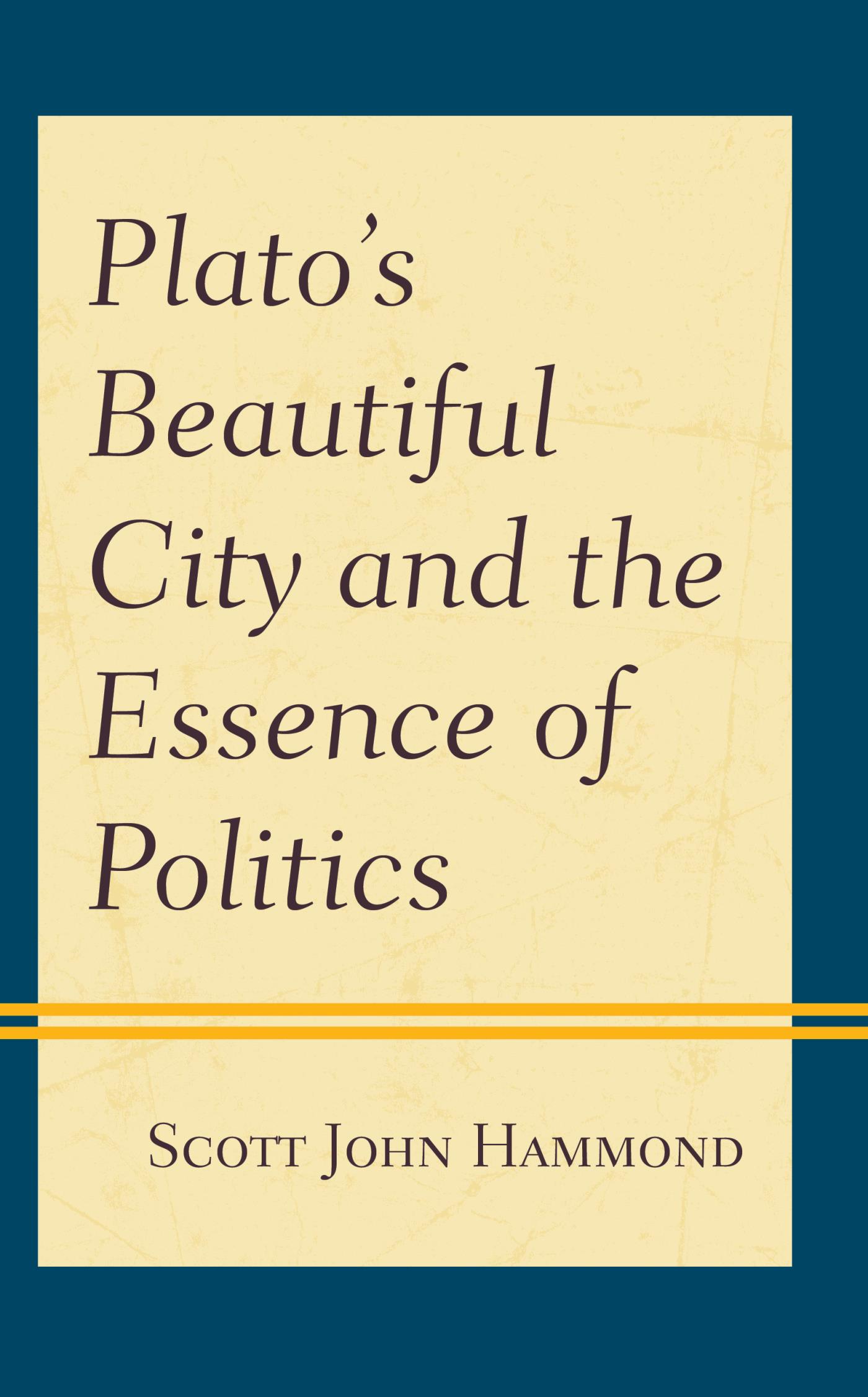
Plato’s Beautiful City and the Essence of Politics In Plato's political theory we discover the essence of politics, which provides the requisite lessons to understand political as it is and should be. As there is a Form of the Good, there is a Form of the Polis, discerned in Plato's philosophy and as real for us as it was for him. POLITICAL SCIENCE,History & Theory

Mutual Aid Mutual aid is the radical act of caring for each other while working to change the world. Around the globe, people are faced with a spiralling succession of crises, from the Covid-19 pandemic and climate change-induced fires, floods, and storms to the ongoing horrors of mass incarceration, racist policing, brutal immigration enforcement, endemic gender violence, and severe wealth inequality. As governments fail to respond to—or actively engineer—each crisis, ordinary people are finding bold and innovative ways to share resources and support the vulnerable. Survival work, when done alongside social movement demands for transformative change, is called mutual aid. This book is about mutual aid: why it is so important, what it looks like, and how to do it. It provides a grassroots theory of mutual aid, describes how mutual aid is a crucial part of powerful movements for social justice, and offers concrete tools for organizing, such as how to work in groups, how to foster a collective decision-making process, how to prevent and address conflict, and how to deal with burnout. Writing for those new to activism as well as those who have been in social movements for a long time, Dean Spade draws on years of organizing to offer a radical vision of community mobilization, social transformation, compassionate activism, and solidarity. POLITICAL SCIENCE,History & Theory
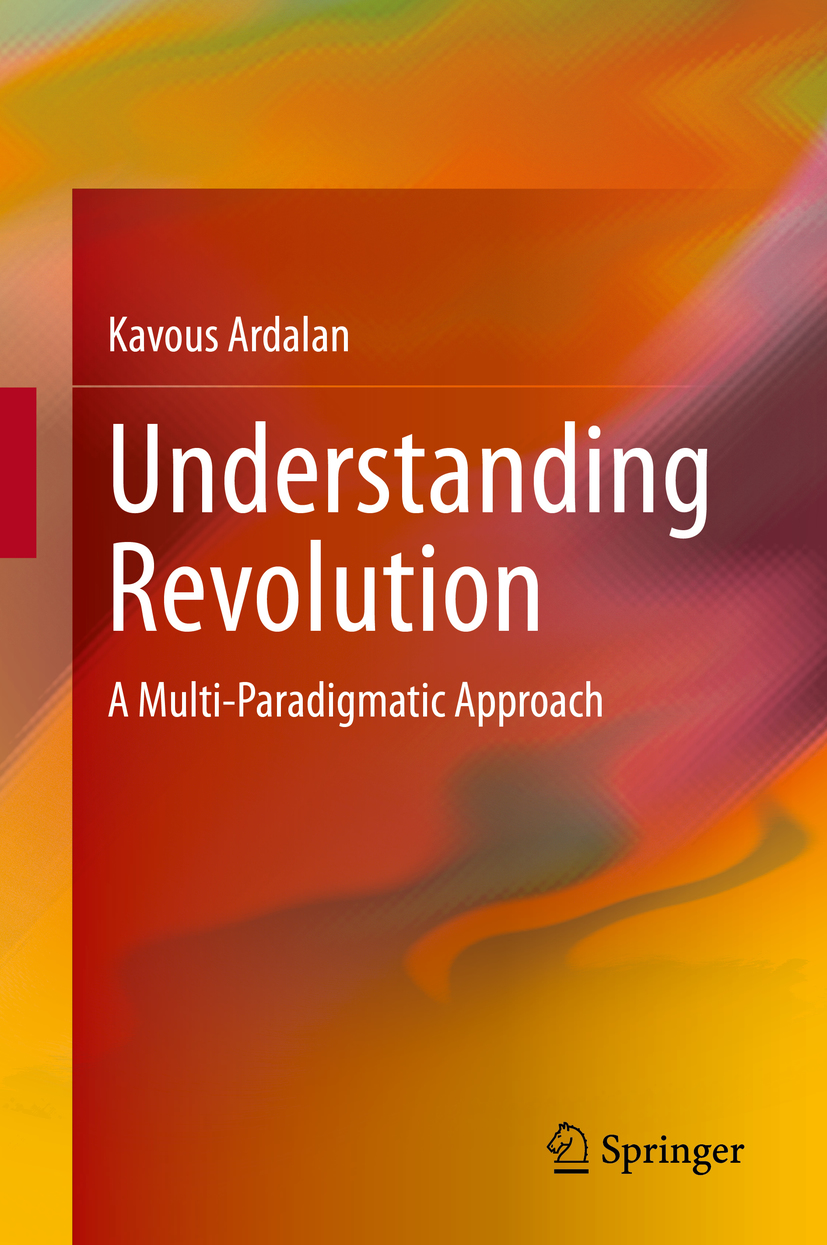
Understanding Revolution This book applies a multiparadigmatic philosophical frame of analysis to the topic of social revolution. Crossing two disciplines and lines of literature—social philosophy and social revolution—this book considers different aspects of social revolution and discusses each aspect from four diverse paradigmatic viewpoints: functionalist, interpretive, radical humanist, and radical structuralist. The four paradigms are founded upon different assumptions about the nature of social science and the nature of society. Each paradigm generates theories, concepts, and analytical tools that are different from those of other paradigms. An understanding of different paradigms leads to a more balanced understanding of the multi-faceted nature of the subject matter. In this book, the first chapter reviews the four paradigms. Using the Iranian Revolution as exemplar, the next few chapters provide paradigmatic explanations for a particular aspect of revolution: culture, religion, ideology. With this background, the book introduces a comprehensive approach to the understanding of revolution. The final chapter concludes by recommending further paradigmatic diversity. This book will be of particular interest to students and researchers interested in social revolution, political sociology, and political theory. POLITICAL SCIENCE,History & Theory

The Sovereign Sovereignty is among the most important phenomena for making sense of political life. But there are many mistaken assumptions associated with the concept. This book provides a new and somewhat unorthodox interpretation of it from the standpoint of a theory of practice. The Sovereign responds to pressing political issues of our time, like immigration and refugees, transnationalism and populism, the prospects for democracy, and the relationship between civil society and the state. The chapters trace the concept of sovereignty from its origins in political theory, providing perspective and insights that leave the reader with a phenomenological sketch of the sovereign. Bronner transforms our ideas about political power, what it is, how it has been used, and how it can be used. His new theory of sovereignty concludes with twenty-five provocative theses on the sovereign’s role in modern capitalist society. The Sovereign is a novel and unparalleled overview of a crucial concept by an influential thinker. It is especially and particularly recommended to scholars and student of comparative politics, international relations, contemporary political theory, and the wider general public. POLITICAL SCIENCE,History & Theory
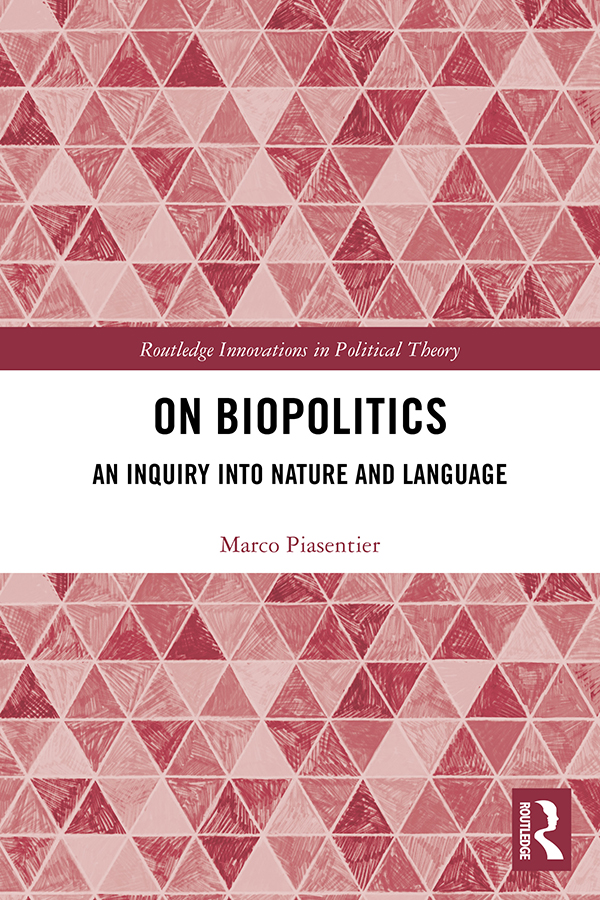
On Biopolitics In On Biopolitics, Marco Piasentier discusses one of the most persistent questions in biopolitical theory – the divide between nature and language – and attempts to redraw the conceptual map which has traditionally defined the permissible paths to address this question. Taking his cue from Foucault’s exhortation to think philologically and biologically, Piasentier traverses the main theoretical and methodological frameworks which have informed the biopolitical debate on nature and language, biology and politics. Biopolitical theory becomes the center of gravity for an investigation encompassing diverse philosophical models, from the Heideggerian linguistic turn to post-Darwinian naturalism. The divide between traditions is not proof of an impossible encounter, but constitutes the site for a new conceptual topography. Working in this interdisciplinary space, Piasentier puts into question the command of language and the ends of nature: two vestiges of a ‘human, all too human’ worldview that preclude the possibility of thinking philologically and biologically about biopolitics. On Biopolitics: An Inquiry into Nature and Language is essential reading for humanities and social sciences scholars with an interest in moving beyond debates about nature and language. POLITICAL SCIENCE,History & Theory
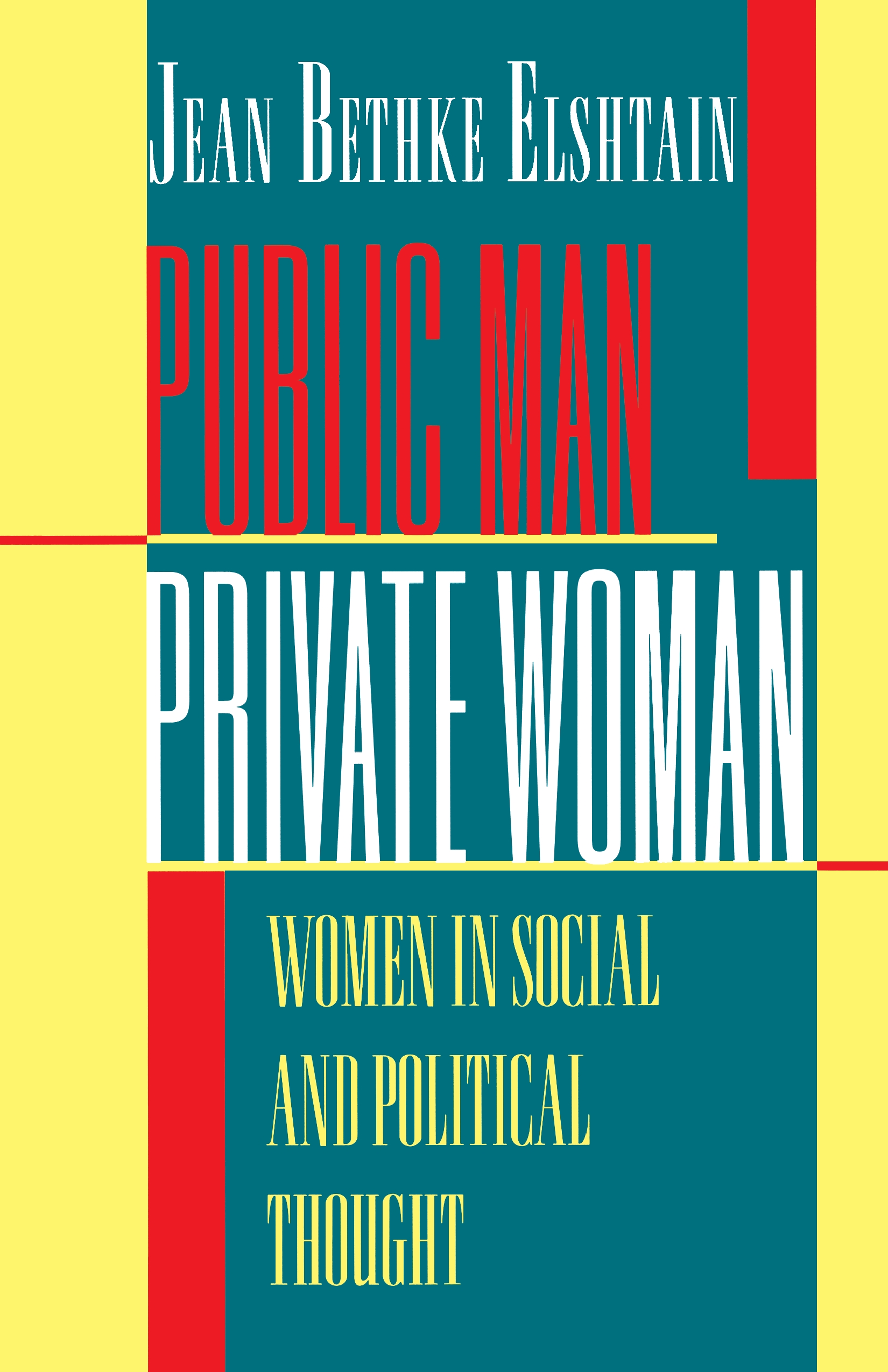
Public Man, Private Woman Focusing on the Western philosophical tradition and the work of contemporary feminists, Jean Elshtain explores the general tendency to assert the primacy of the public world—the political sphere dominated by men—and to denigrate the private world—the familial sphere dominated by women. She offers her own positive reconstruction of the public and the private in a feminist theory that reaffirms the importance of the family and envisions an "ethical polity." POLITICAL SCIENCE,History & Theory

My Revision Notes Exam board: Edexcel Level: A-level Subject: Politics First teaching: September 2017 First exams: Summer 2018 Target success in politics with this proven formula for effective, structured revision; key content coverage is combined with exam-style tasks and practical tips to create a revision guide that students can rely on to review, strengthen and test their knowledge. With My Revision Notes, every student can: - Plan and manage a successful revision programme using the topic-by-topic planner- Consolidate subject knowledge by working through clear and focused content coverage- Test understanding and identify areas for improvement with regular 'Now Test Yourself' tasks and answers- Improve exam technique through practice questions, expert tips and examples of typical mistakes to avoid- Get exam ready with extra quick quizzes and answers to the practice questions available online POLITICAL SCIENCE,History & Theory

The Politics of Horror The Politics of Horror features contributions from scholars in a variety of fields—political science, English, communication studies, and others—that explore the connections between horror and politics. How might resources drawn from the study of politics inform our readings of, and conversations about, horror? In what ways might horror provide a useful lens through which to consider enduring questions in politics and political thought? And what insights might be drawn from horror as we consider contemporary political issues? In turning to horror, the contributors to this volume offer fresh provocations to inform a broad range of discussions of politics. POLITICAL SCIENCE,History & Theory
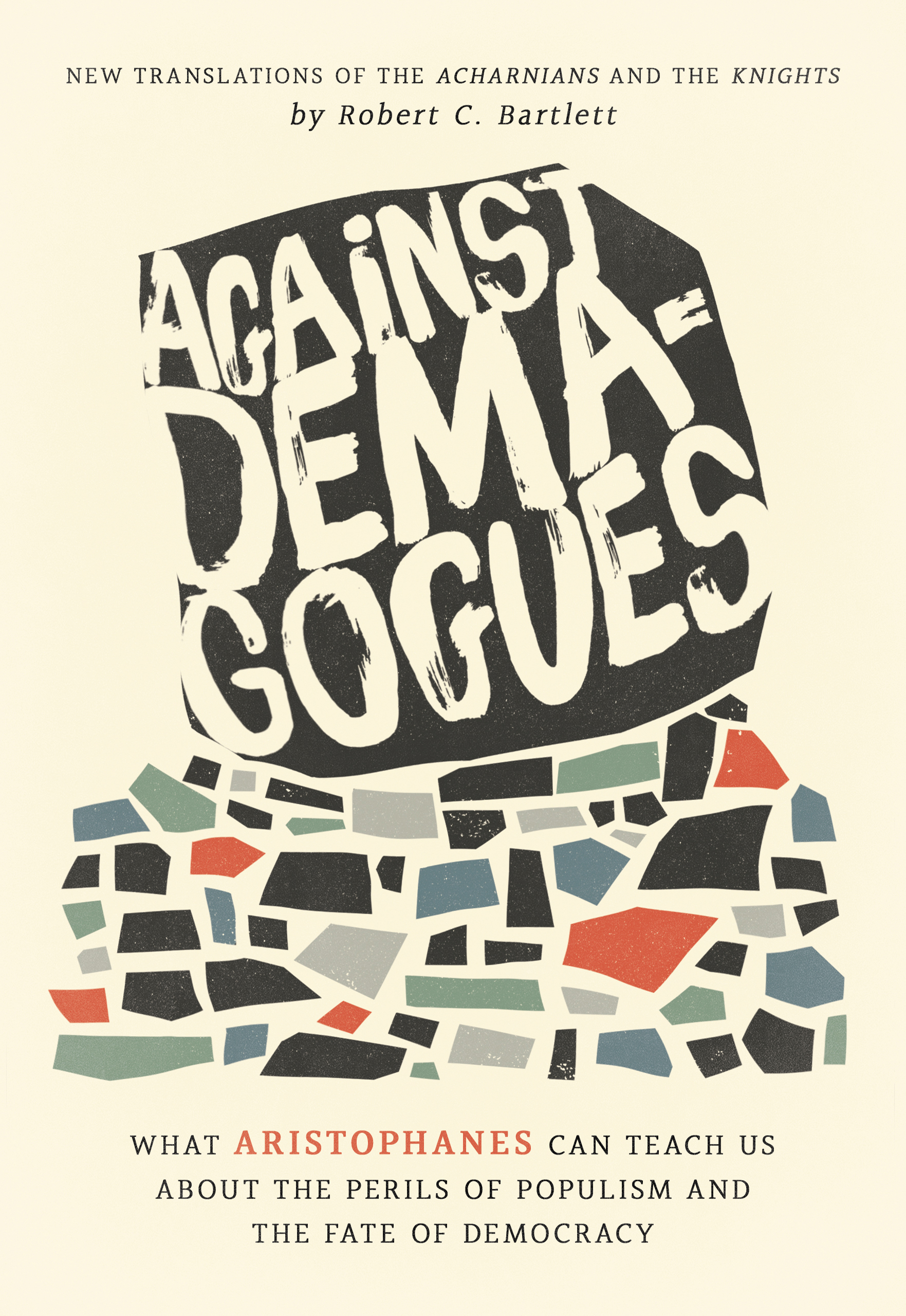
Against Demagogues Timeless comedies on resisting tyranny from one of history’s greatest comic playwrights. Against Demagogues presents Robert C. Bartlett's new translations of Aristophanes' most overtly political works, the Acharnians and the Knights. In these fantastically inventive, raucous, and raunchy comedies, the powerful politician Cleon proves to be democracy's greatest opponent. With unrivalled power, both plays make clear the dangers to which democracies are prone, especially the threats posed by external warfare, internal division, and class polarization. Combating the seductive allure of demagogues and the damage they cause, Against Demagogues disentangles Aristophanes' serious teachings from his many jokes and pratfalls, substantiating for modern readers his famous claim to "teach justice" while "making a comedy" of the city. The book features an interpretive essay for each play, expertly guiding readers through the most important plot points, explaining the significance of various characters, and shedding light on the meaning of the plays' often madcap episodes. Along with a contextualizing introduction, Bartlett offers extensive notes explaining the many political, literary, and religious references and allusions. Aristophanes' comedic skewering of the demagogue and his ruthless ambition—and of a community so ill-informed about the doings of its own government, so ready to believe in empty promises and idle flattery—cannot but resonate strongly with readers today around the world. POLITICAL SCIENCE,History & Theory
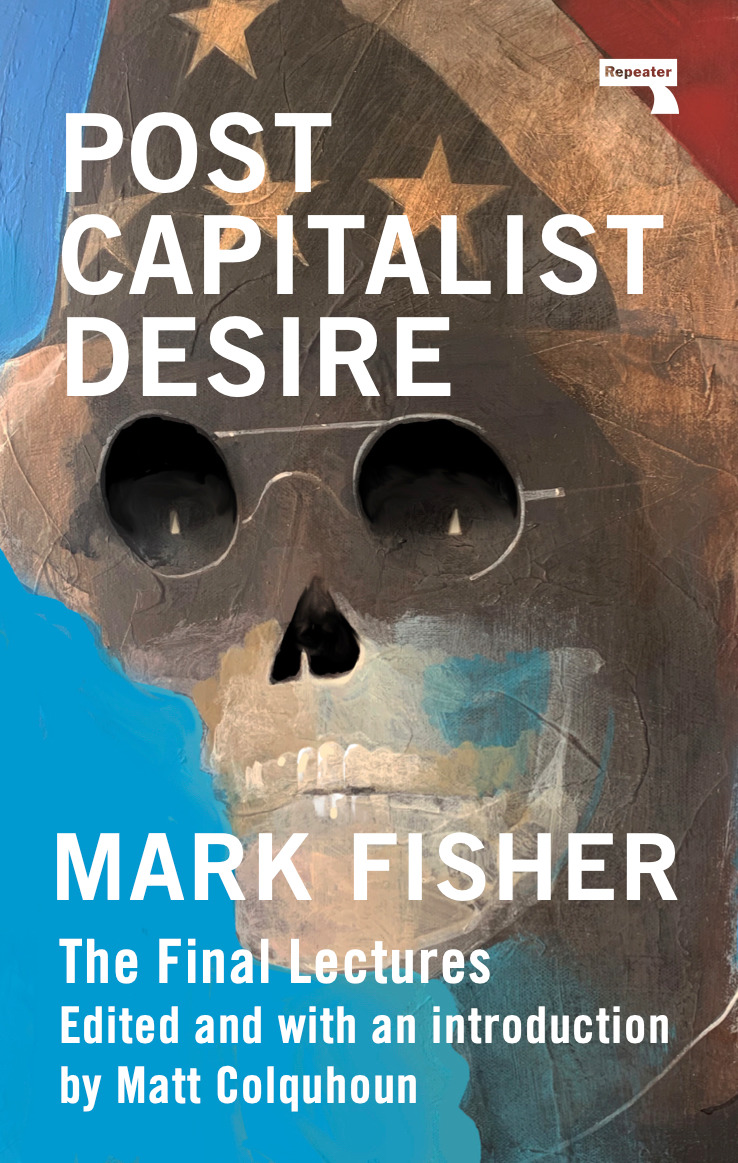
Postcapitalist Desire A collection of transcripts from Mark Fisher's final series of lectures at Goldsmiths, University of London, in late 2016. Edited with an introduction by Matt Colquhoun, this collection of lecture notes and transcriptions reveals acclaimed writer and blogger Mark Fisher in his element -- the classroom -- outlining a project that Fisher's death left so bittersweetly unfinished. Beginning with that most fundamental of questions -- "Do we really want what we say we want?" -- Fisher explores the relationship between desire and capitalism, and wonders what new forms of desire we might still excavate from the past, present, and future. From the emergence and failure of the counterculture in the 1970s to the continued development of his left-accelerationist line of thinking, this volume charts a tragically interrupted course for thinking about the raising of a new kind of consciousness, and the cultural and political implications of doing so. For Fisher, this process of consciousness raising was always, fundamentally, psychedelic -- just not in the way that we might think... POLITICAL SCIENCE,History & Theory

The four dimensions of power In this accessible and sophisticated exploration of the nature and workings of social and political power, Mark Haugaard examines the interrelation between domination and empowerment. Building upon the perspectives of Steven Lukes, Michel Foucault, Amy Allen, Hannah Arendt, Anthony Giddens, Pierre Bourdieu and others, Haugaard offers a clear theoretical framework, delineating power in four interrelated dimensions.The first and second dimensions of power entail two different types of social conflict. The third dimension concerns tacit knowledge, uses of truth and reification. Drawing upon genealogical theory and accounts of slavery as social death, the fourth dimension of power concerns the power to create social subjects. The book concludes with an original normative pragmatist power-based account of democracy.Offering lucid and entertaining illustrations of complex theoretical perspectives, this book is essential reading for undergraduates, postgraduates and academics, while offering an indispensable guide for activists wishing to understand domination, resistance and empowerment. POLITICAL SCIENCE,History & Theory
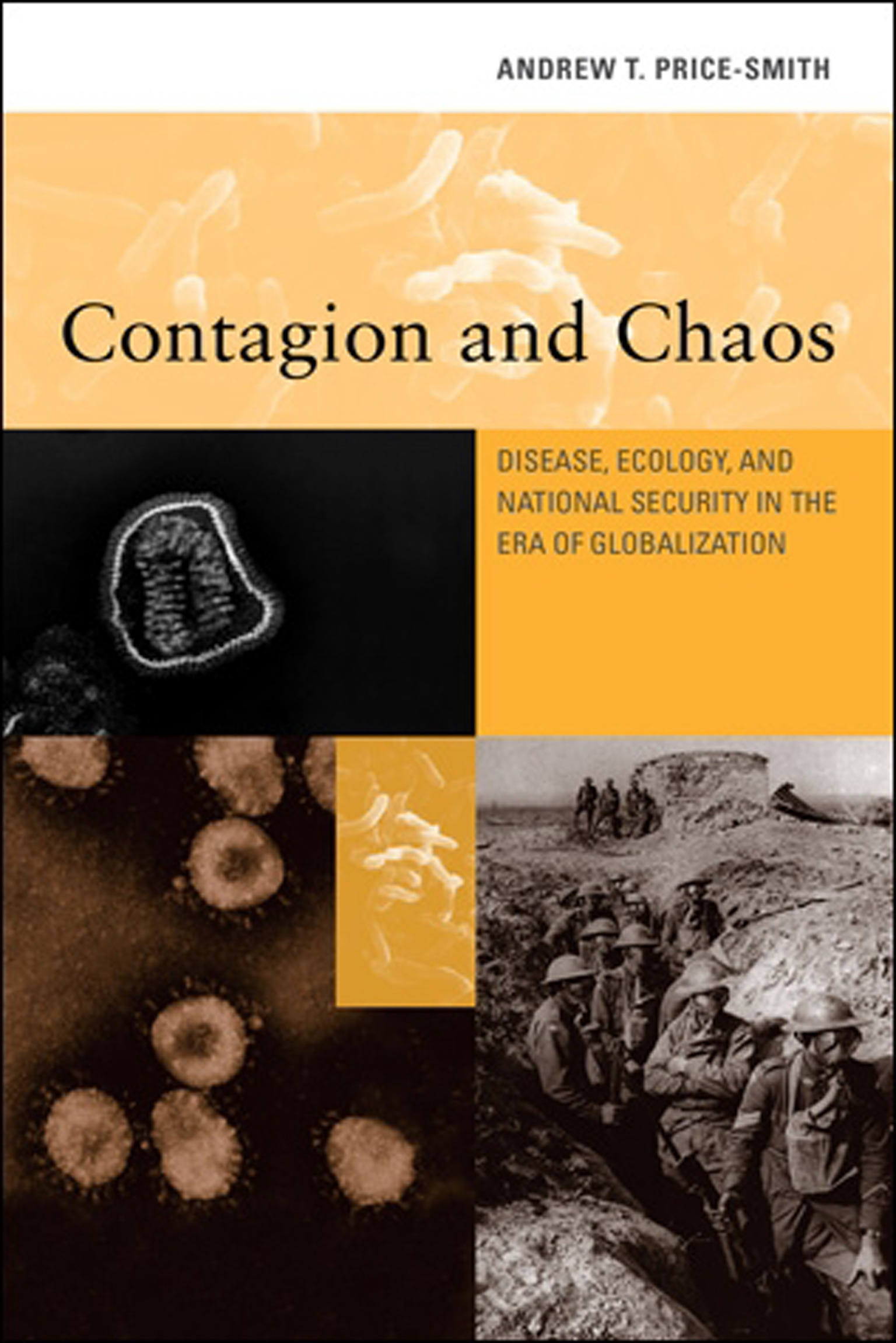
Contagion and Chaos An analysis of infectious disease as a threat to national security that examines the destabilizing effects of the 1918 Spanish Flu pandemic, HIV/AIDS in sub-Saharan Africa, SARS, and Mad Cow Disease. Historians from Thucydides to William McNeill have pointed to the connections between disease and civil society. Political scientists have investigated the relationship of public health to governance, introducing the concept of health security. In Contagion and Chaos, Andrew Price-Smith offers the most comprehensive examination yet of disease through the lens of national security. Extending the analysis presented in his earlier book The Health of Nations, Price-Smith argues that epidemic disease represents a direct threat to the power of a state, eroding prosperity and destabilizing both its internal politics and its relationships with other states. He contends that the danger of an infectious pathogen to national security depends on lethality, transmissability, fear, and economic damage. Moreover, warfare and ecological change contribute to the spread of disease and act as “disease amplifiers.” Price-Smith presents a series of case studies to illustrate his argument: the Spanish influenza pandemic of 1918-19 (about which he advances the controversial claim that the epidemic contributed to the defeat of Germany and Austria); HIV/AIDS in sub-Saharan Africa (he contrasts the worst-case scenario of Zimbabwe with the more stable Botswana); bovine spongiform encephalopathy (also known as mad cow disease); and the SARS contagion of 2002-03. Emerging infectious disease continues to present a threat to national and international security, Price-Smith argues, and globalization and ecological change only accelerate the danger. POLITICAL SCIENCE,History & Theory

A Nuclear Winter's Tale The rise and fall of the concept of nuclear winter, played out in research activity, public relations, and Reagan-era politics. The nuclear winter phenomenon burst upon the public's consciousness in 1983. Added to the horror of a nuclear war's immediate effects was the fear that the smoke from fires ignited by the explosions would block the sun, creating an extended “winter” that might kill more people worldwide than the initial nuclear strikes. In A Nuclear Winter's Tale, Lawrence Badash maps the rise and fall of the science of nuclear winter, examining research activity, the popularization of the concept, and the Reagan-era politics that combined to influence policy and public opinion. Badash traces the several sciences (including studies of volcanic eruptions, ozone depletion, and dinosaur extinction) that merged to allow computer modeling of nuclear winter and its development as a scientific specialty. He places this in the political context of the Reagan years, discussing congressional interest, media attention, the administration's plans for a research program, and the Defense Department's claims that the arms buildup underway would prevent nuclear war, and thus nuclear winter. A Nuclear Winter's Tale tells an important story but also provides a useful illustration of the complex relationship between science and society. It examines the behavior of scientists in the public arena and in the scientific community, and raises questions about the problems faced by scientific Cassandras, the implications when scientists go public with worst-case scenarios, and the timing of government reaction to startling scientific findings. POLITICAL SCIENCE,History & Theory
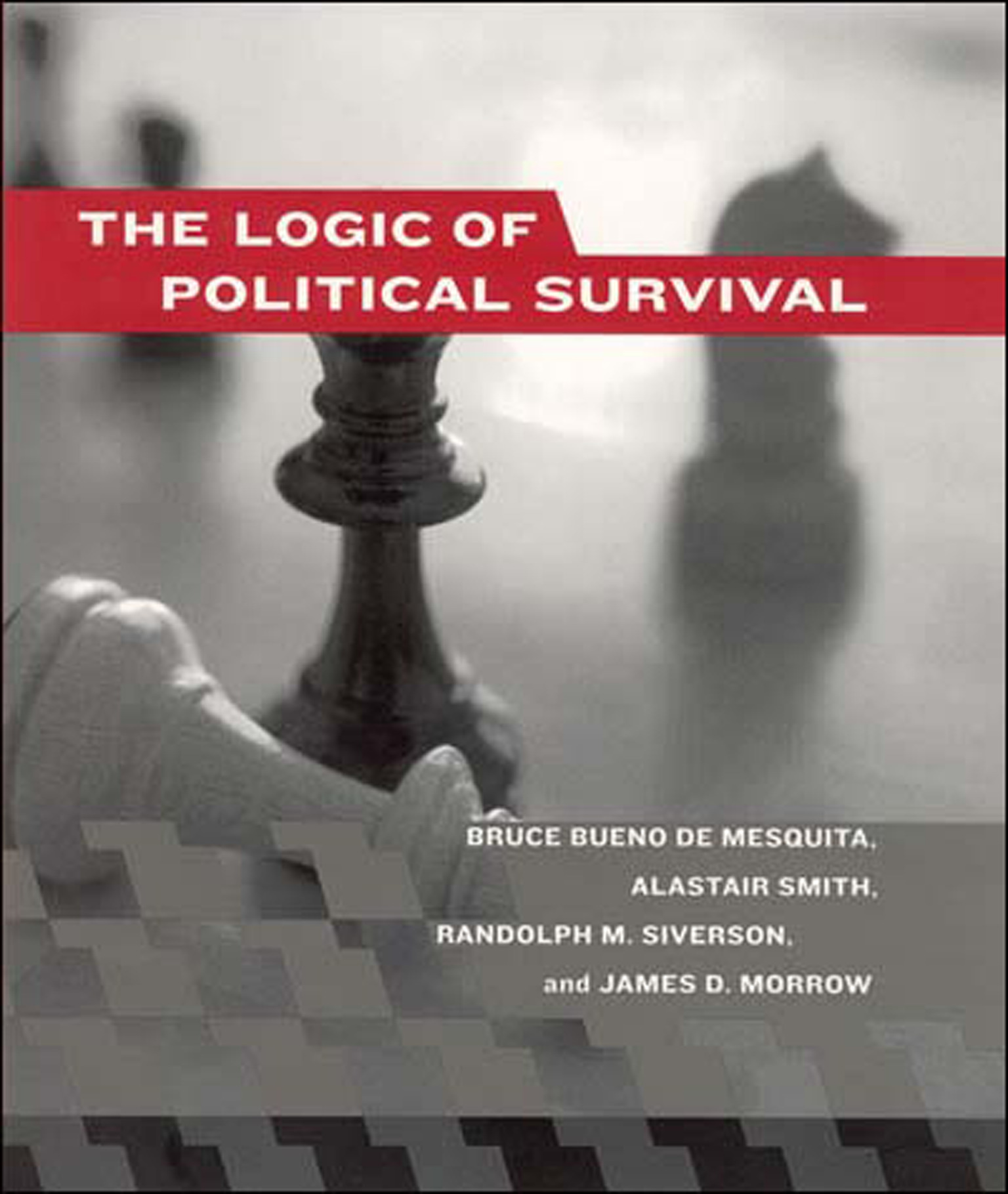
The Logic of Political Survival The authors of this ambitious book address a fundamental political question: why are leaders who produce peace and prosperity turned out of office while those who preside over corruption, war, and misery endure? Considering this political puzzle, they also answer the related economic question of why some countries experience successful economic development and others do not. The authors construct a provocative theory on the selection of leaders and present specific formal models from which their central claims can be deduced. They show how political leaders allocate resources and how institutions for selecting leaders create incentives for leaders to pursue good and bad public policy. They also extend the model to explain the consequences of war on political survival. Throughout the book, they provide illustrations from history, ranging from ancient Sparta to Vichy France, and test the model against statistics gathered from cross-national data. The authors explain the political intuition underlying their theory in nontechnical language, reserving formal proofs for chapter appendixes. They conclude by presenting policy prescriptions based on what has been demonstrated theoretically and empirically. POLITICAL SCIENCE,History & Theory
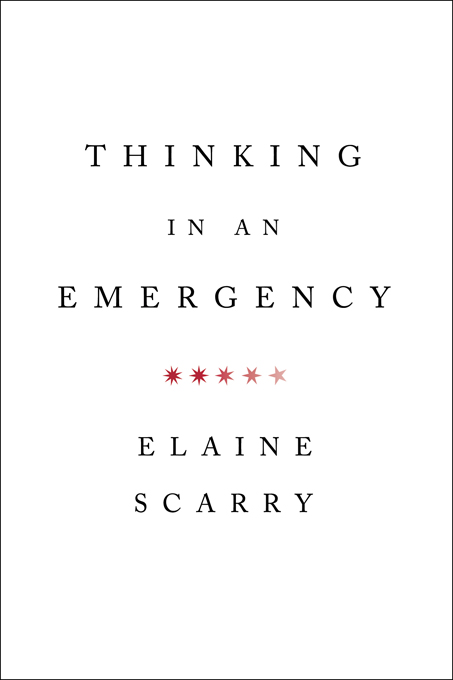
Thinking in an Emergency (Norton Global Ethics Series) Award-winning critic Elaine Scarry provides a vital new assessment of leadership during crisis that ensures the protection of democratic values. In Thinking in an Emergency, Elaine Scarry lays bare the realities of “emergency†politics and emphasizes what she sees as the ultimate ethical concern: “equality of survival.†She reveals how regular citizens can reclaim the power to protect one another and our democratic principles. Government leaders sometimes argue that the need for swift national action means there is no time for the population to think, deliberate, or debate. But Scarry shows that clear thinking and rapid action are not in opposition. Examining regions as diverse as Japan, Switzerland, Ethiopia, and Canada, Scarry identifies forms of emergency assistance that represent “thinking†at its most rigorous and remarkable. She draws on the work of philosophers, scientists, and artists to remind us of our ability to assist one another, whether we are called upon to perform acts of rescue as individuals, as members of a neighborhood, or as citizens of a country. POLITICAL SCIENCE,History & Theory
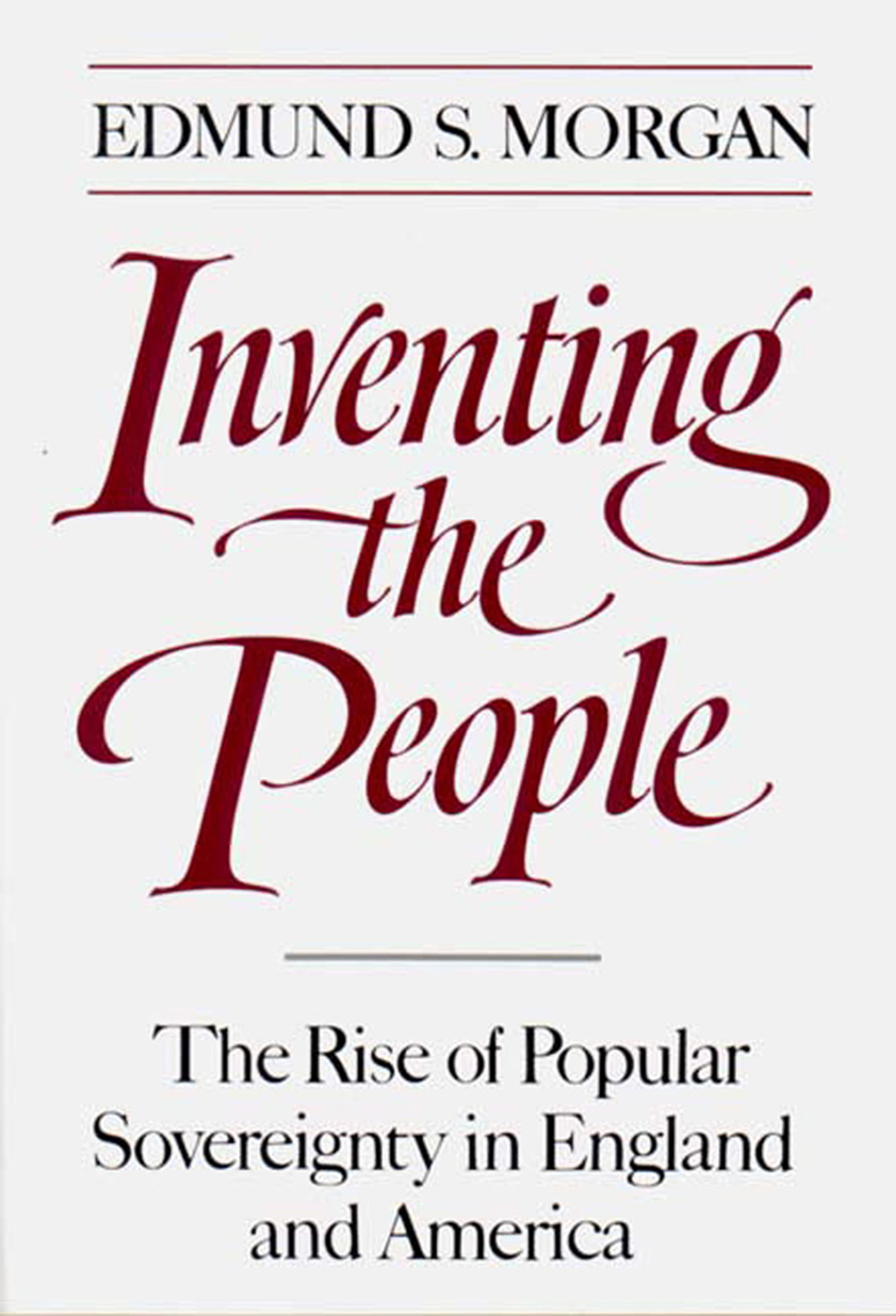
Inventing the People "The best explanation that I have seen for our distinctive combination of faith, hope and naiveté concerning the governmental process." —Michael Kamman, Washington Post This book makes the provocative case here that America has remained politically stable because the Founding Fathers invented the idea of the American people and used it to impose a government on the new nation. His landmark analysis shows how the notion of popular sovereignty—the unexpected offspring of an older, equally fictional notion, the "divine right of kings"—has worked in our history and remains a political force today. POLITICAL SCIENCE,History & Theory
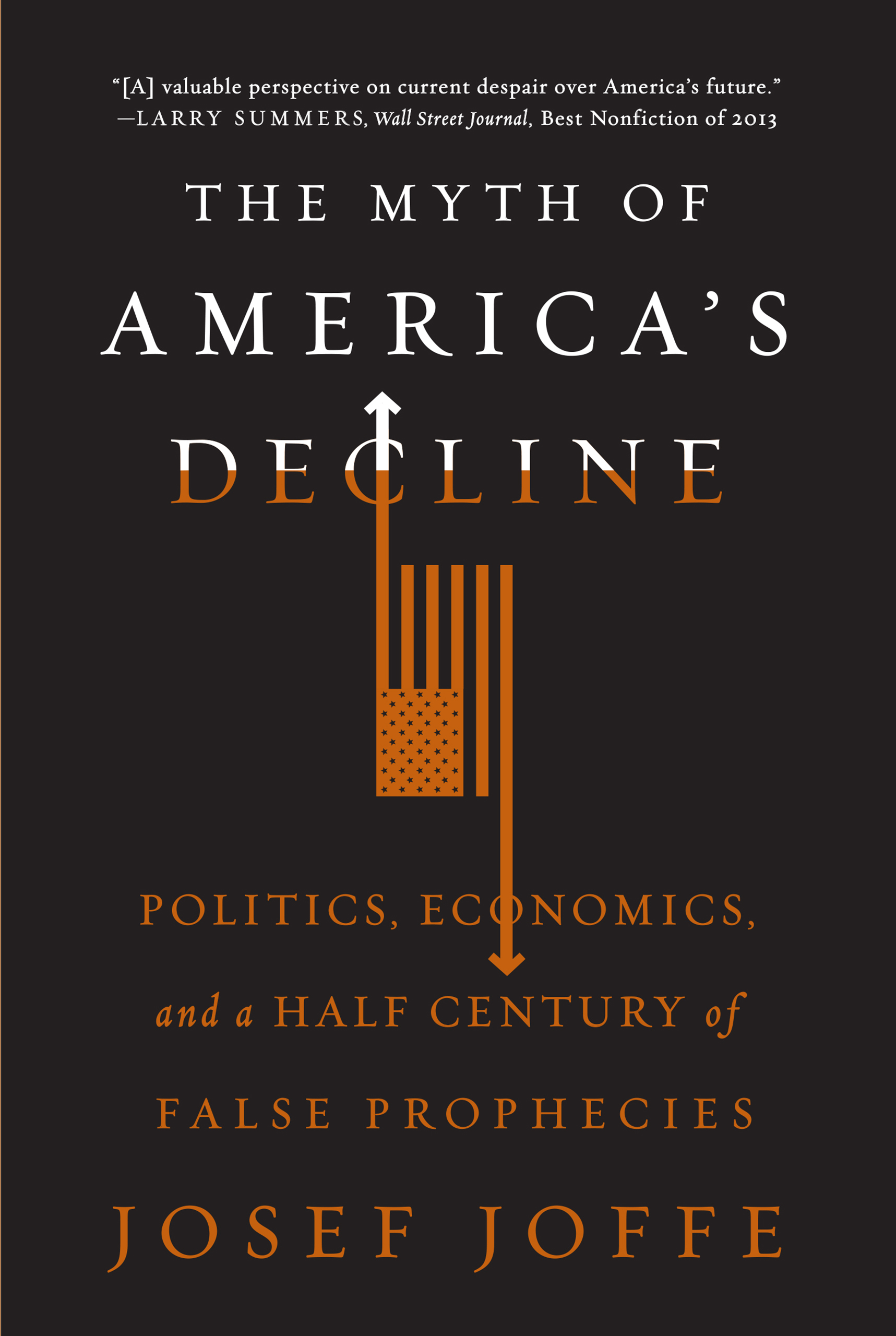
The Myth of America's Decline “A bracing and intelligent reminder that, for all its woes, America remains extraordinarily dynamic, innovative, and resilient.â€â€”Fareed Zakaria Hailed by the Wall Street Journal as one of the best books of 2013, The Myth of America’s Decline is a highly provocative look at how the United States, for all its failings, continues to be the leading business, political, and intellectual model for all other nations. In a world where America bashers constantly chortle that the United States is in decline, Josef Joffe, using lively historical examples and empirical economic models, demonstrates that these doomsday contentions are flawed, and that America—even when compared with a resurgent China—is the land where the future is being born. POLITICAL SCIENCE,History & Theory
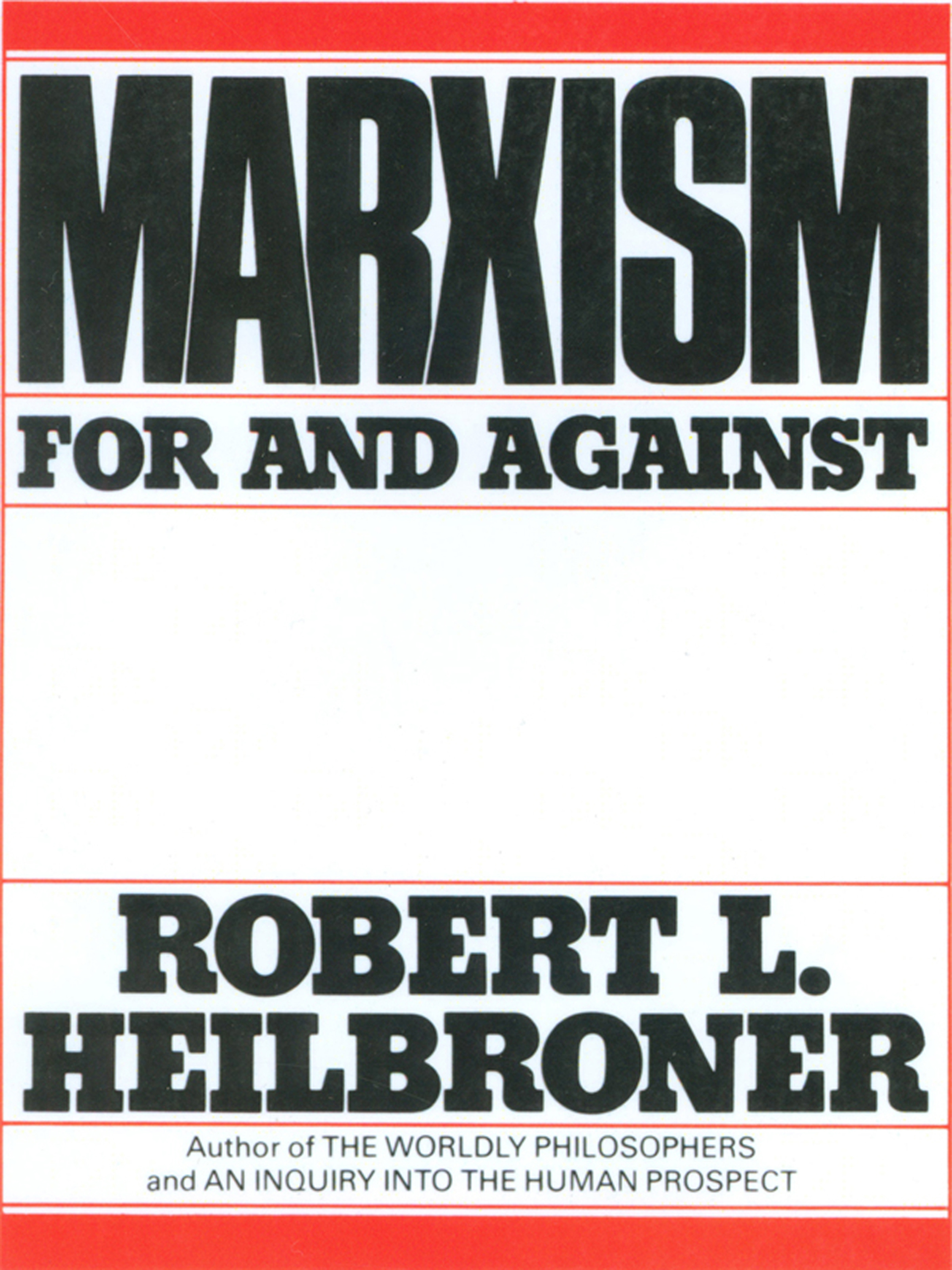
Marxism "Genuinely open-minded and inquiring. . . .it intelligently summarizes and shrewdly questions four central topics of Marxist thought—the dialectical approach to philosophy, the materialist interpretation of history, the socio-analysis of capitalism and the commitment to socialism." —Raymond Williams, Cambridge University In the lucid style and engaging manner that have become his trademark, Robert L. Heilbroner explains and explores the central elements of Marxist thought: the meaning of a "dialectical" philosophy, the usefulness and problems of a " materialist" interpretation" of history, the power of Marx's "socioanalytic" penetration of capitalism, and the hopes and disconcerting problems involved in a commitment to socialism. Scholarly without being academic, searching without assuming a prior knowledge of the subject, Dr. Heilbroner enables us to appreciate the greatness of Mark while avoiding an uncritical stance toward his work. POLITICAL SCIENCE,History & Theory
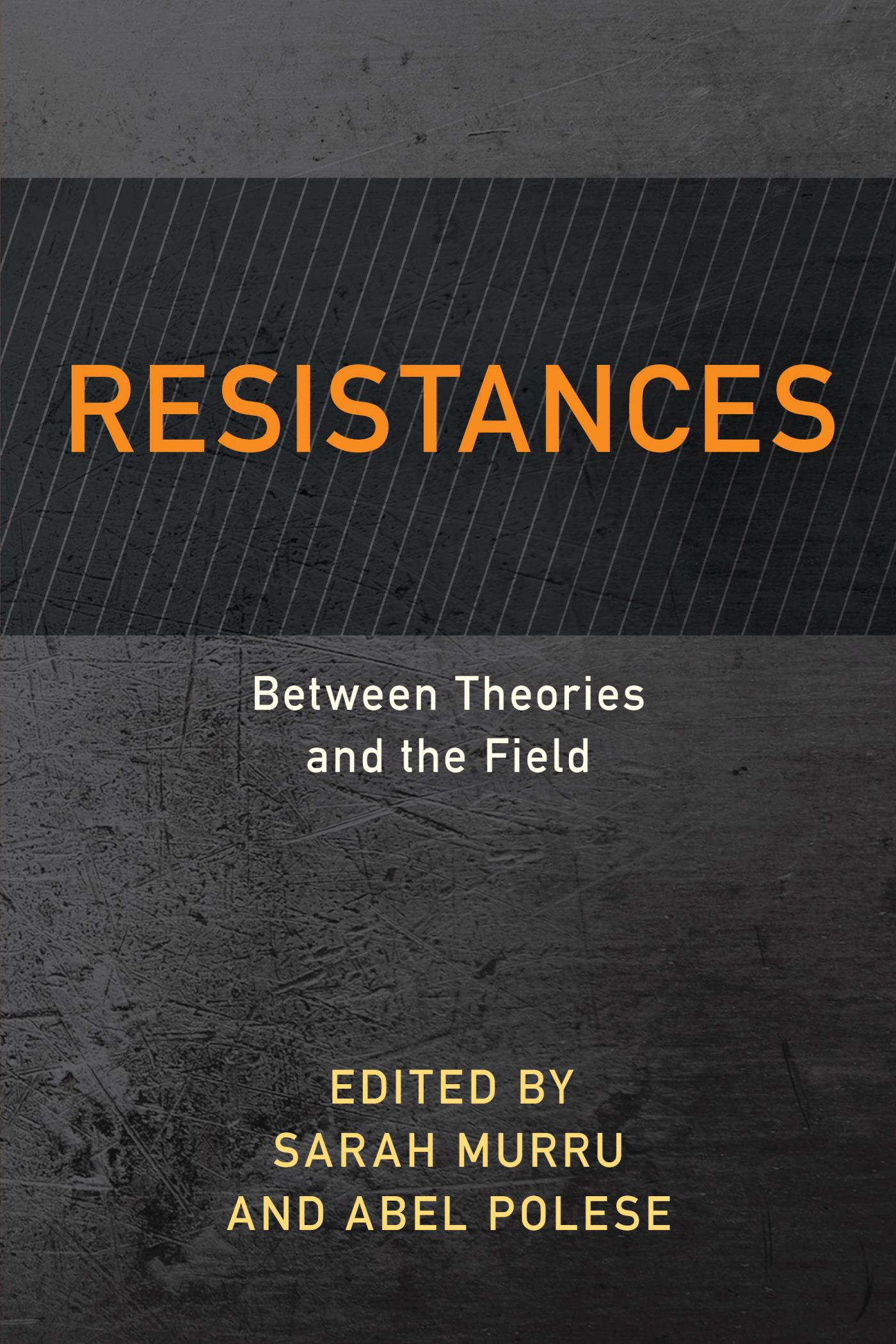
Resistances This book examines multiple forms of resistance. POLITICAL SCIENCE,History & Theory

Votes for Women! The American Woman Suffrage Movement and the Nineteenth Amendment Votes for Women! provides an updated consideration of the questions raised by the mass movement to gain equality and access to power in our democracy. It interprets the campaigns for woman suffrage from the 1830s until 1920, analyzes the impact of the 19th amendment, and presents primary documents to allow a glimpse into the minds of those who campaigned for and against woman suffrage. The book's examination of the 70-year woman suffrage campaign movement shows how the movement faced enormous barriers, was perceived as threatening the very core of accepted beliefs, and was a struggle that showcased the efforts of strong protagonists and brilliant organizers who were intellectually innovative and yet were reflective of the great divides of race, ethnicity, religion, economics, and region existing across the nation. Included within the narrative section are biographies of significant personalities in the movement, such as militant Alice Paul and anti-suffragist Ida Tarbell as well as more commonly known leaders Elizabeth Cady Stanton and Susan B. Anthony. POLITICAL SCIENCE,History & Theory
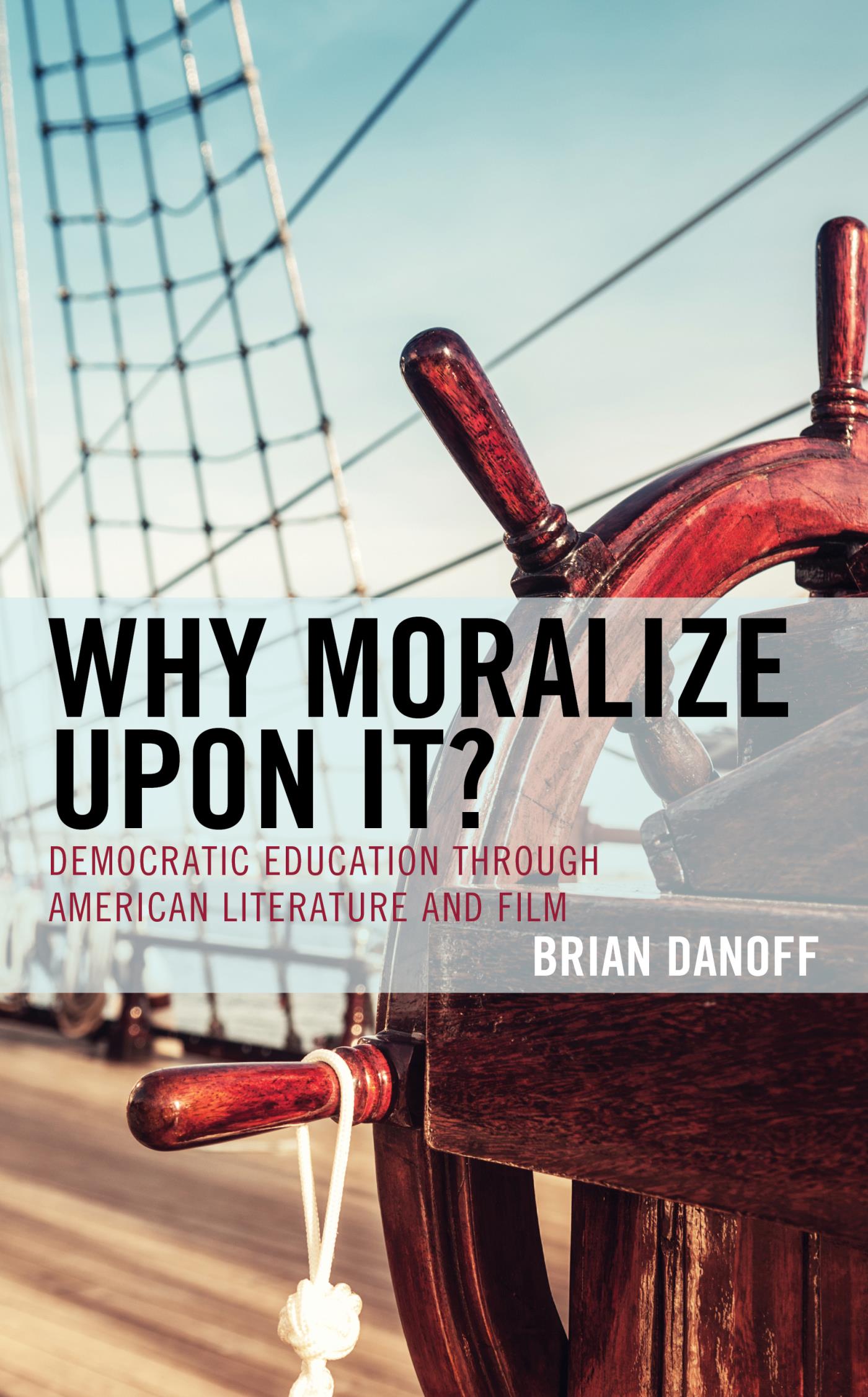
Why Moralize upon It? Danoff argues that novels and films with an ambiguous, nuanced, and tragic outlook help teach citizen-readers how to think through the moral complexities of political issues on which they must render judgment. He claims that some of the most profound American thinking about the nature of democratic leadership has come through works of fiction. POLITICAL SCIENCE,History & Theory
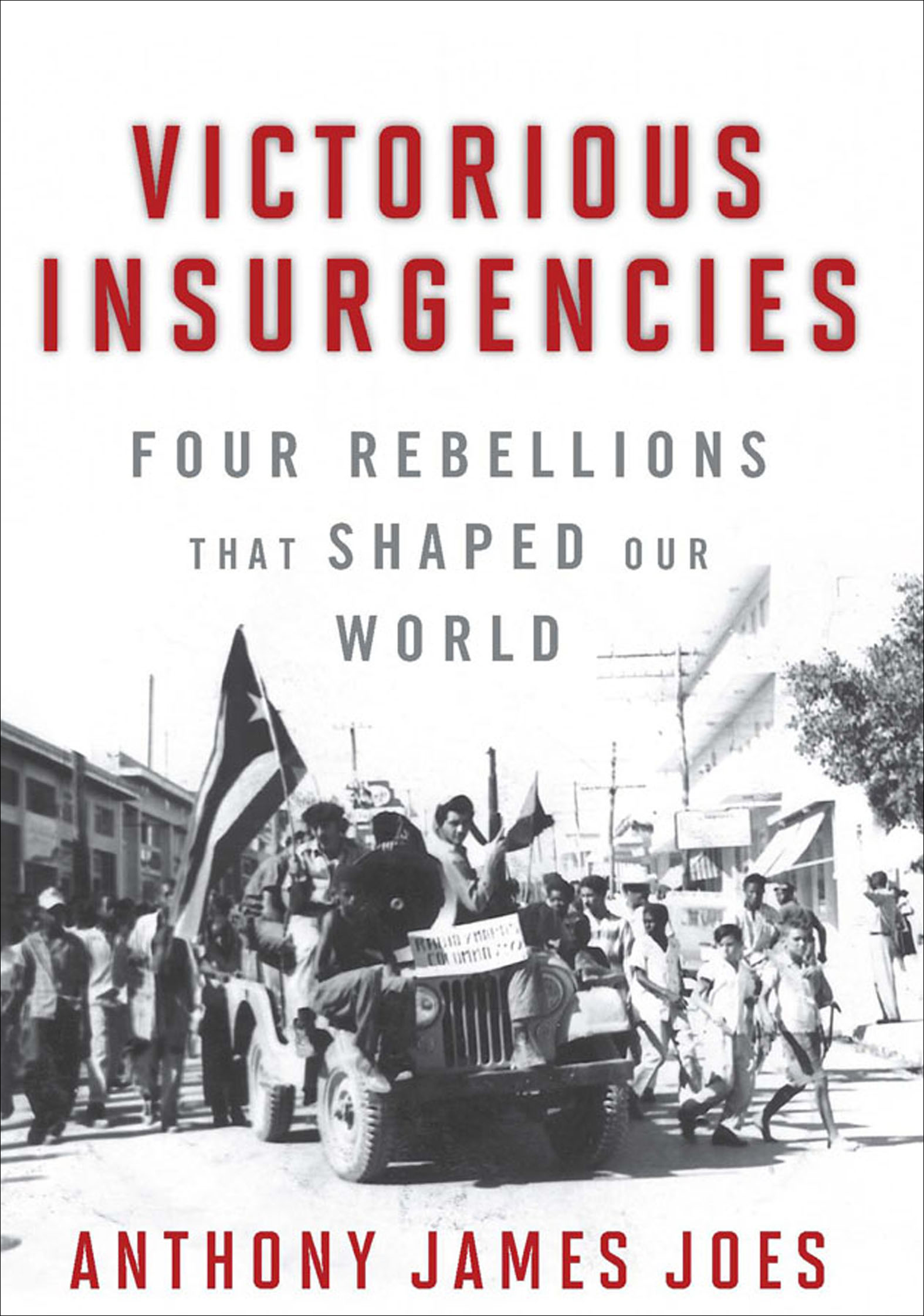
Victorious Insurgencies Insurgencies, especially in the form of guerrilla warfare, continue to erupt across many parts of the globe. Most of these rebellions fail, but Four Rebellions that Shaped Our World analyzes four twentieth-century conflicts in which the success of the insurgents permanently altered the global political arena: the Maoists in China against Chiang Kai-shek and the Japanese in the 1930s and 1940s; the Viet Minh in French Indochina from 1945 to 1954; Castro's followers against Batista in Cuba from 1956 to 1959; and the mujahideen in Soviet Afghanistan from 1980 to 1989. Anthony James Joes illuminates patterns of failed counterinsurgencies that include serious but avoidable political and military blunders and makes clear the critical and often decisive influence of the international setting. Offering provocative insights and timeless lessons applicable to contemporary conflicts in Iraq and Afghanistan, this authoritative and comprehensive book will be of great interest to policy-makers and concerned citizens alike. POLITICAL SCIENCE,History & Theory
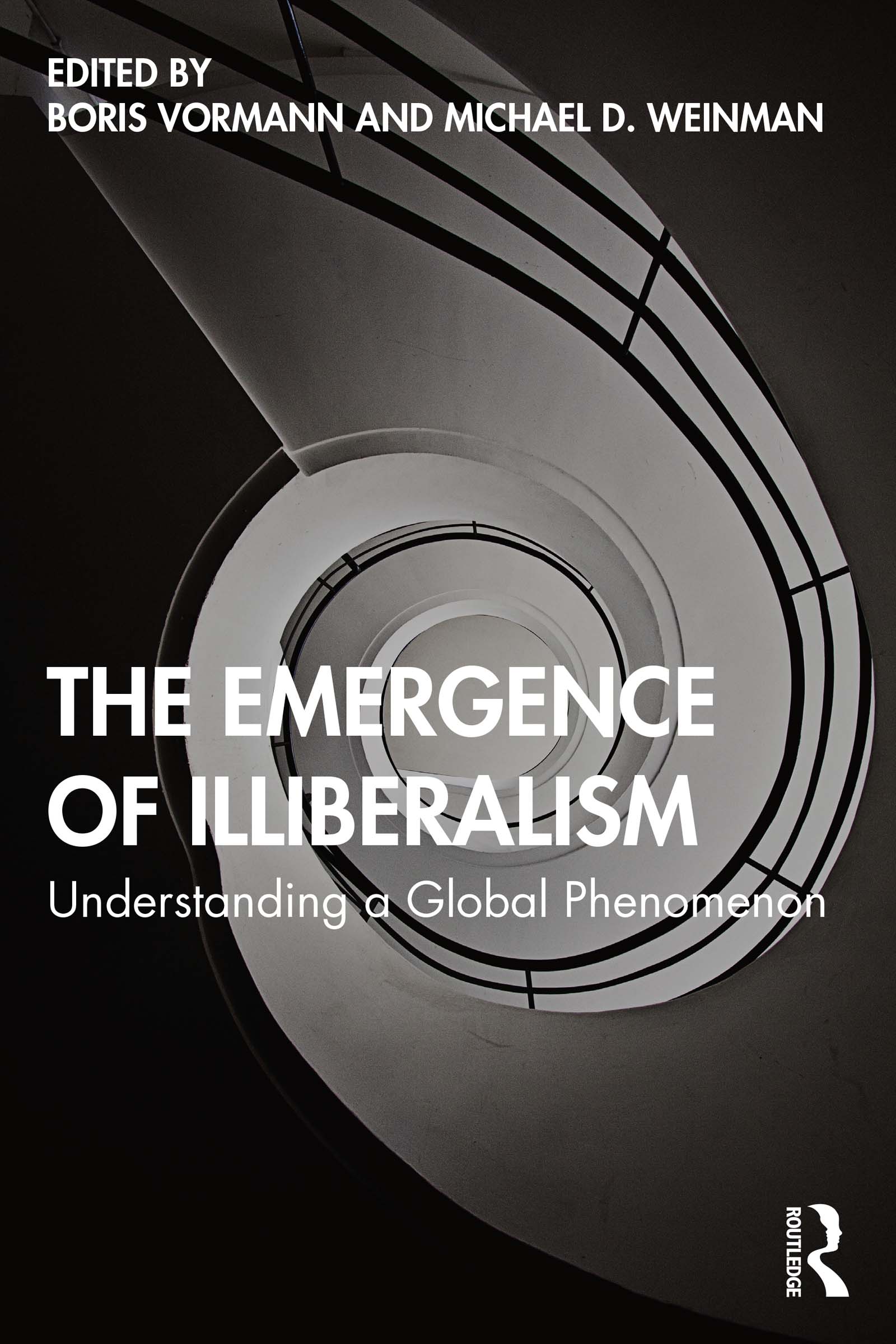
The Emergence of Illiberalism As illiberal and authoritarian trends are on the rise—both in fragile and seemingly robust democracies—there is growing concern about the longevity of liberalism and democracy. The purpose of this volume is to draw on the analytical resources of various disciplines and public policy approaches to reflect on the current standing of liberal democracy. Leading social scientists from different disciplinary backgrounds aim to examine the ideological and structural roots of the current crisis of liberal democracies, in the West and beyond, conceptually and empirically. The volume is divided into two main parts: Part I explores tensions between liberalism and democracy in a longer-term, historical perspective to explain immanent vulnerabilities of liberal democracy. Authors examine the conceptual foundations of Western liberal democracy that have shaped its standing in the contemporary world. What lies at the core of illiberal tendencies? Part II explores case studies from the North Atlantic, Eastern Europe, Turkey, India, Japan, and Brazil, raising questions whether democratic crises, manifested in the rise of populist movements in and beyond the Western context, differ in kind or only in degree. How can we explain the current popular appeal of authoritarian governments and illiberal ideas? The Emergence of Illiberalism will be of great interest to teachers and students of politics, sociology, political theory and comparative government. POLITICAL SCIENCE,History & Theory
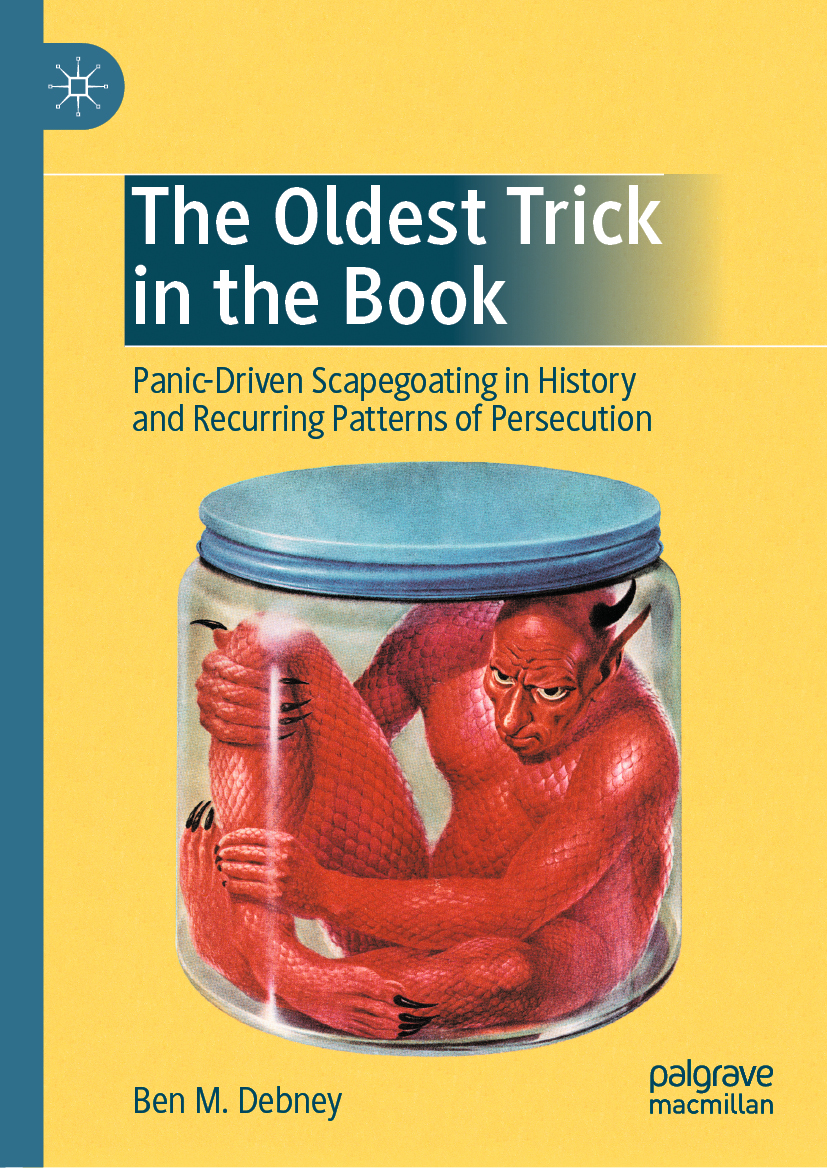
The Oldest Trick in the Book This book investigates the normalisation of blame-shifting within ideological discourse as a broad feature of history, working from Churchill’s truism that history is written by the victors. To that end, it explores historical episodes of political persecution carried out under cover of moral panic, highlighting the process of ‘Othering’ common to each and theorising a historical model of panic-driven scapegoating from the results. Building this model from case studies in witch panic, communist panic and terrorist panic respectively, The Oldest Trick in the Book builds an argument that features common to each case study reflect broader historical patterning consistent with Churchill’s maxim. On this basis it argues that the periodic construction of bogeymen or ‘folk demons’ is a useful device for enabling the kind of victim-playing and victim-blaming critical to protecting elite privilege during periods of crisis and that in being a recurring theme historically, panic-driven scapegoating retains great ongoing value to the privileged and powerful, and thus conspicuously remains an ongoing feature of world politics. POLITICAL SCIENCE,History & Theory
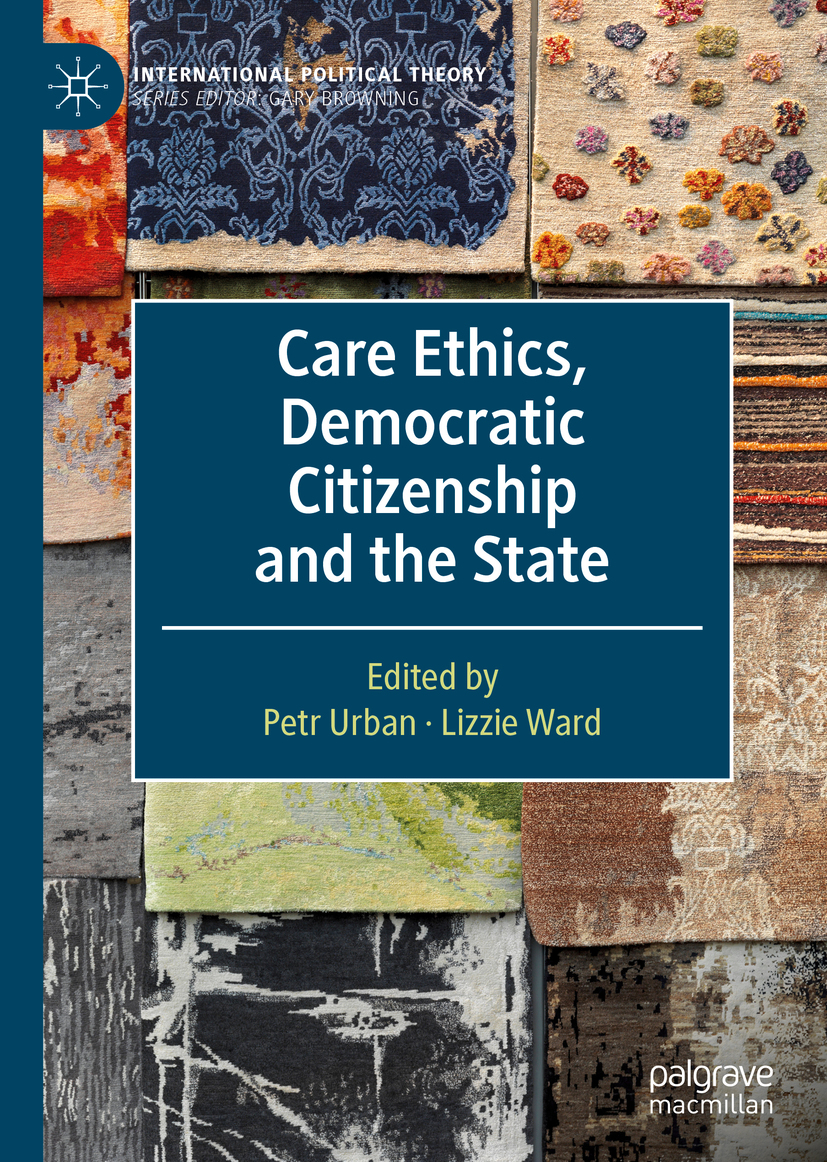
Care Ethics, Democratic Citizenship and the State This book reflects on theoretical developments in the political theory of care and new applications of care ethics in different contexts. The chapters provide original and fresh perspectives on the seminal notions and topics of a politically formulated ethics of care. It covers concepts such as democratic citizenship, social and political participation, moral and political deliberation, solidarity and situated attentive knowledge. It engages with current debates on marketizing and privatizing care, and deals with issues of state care provision and democratic caring institutions. It speaks to the current political and societal challenges, including the crisis of Western democracy related to the rise of populism and identity politics worldwide. The book brings together perspectives of care theorists from three different continents and ten different countries and gives voice to their unique local insights from various socio-political and cultural contexts. Chapter 11 is available open access under a Creative Commons Attribution 4.0 International License via link.springer.com. POLITICAL SCIENCE,History & Theory

Autós Autós traces and reassesses the European construction of individuals from ancient Greece to the present in major literary, philosophical, juridical, scientific, and political texts. POLITICAL SCIENCE,History & Theory
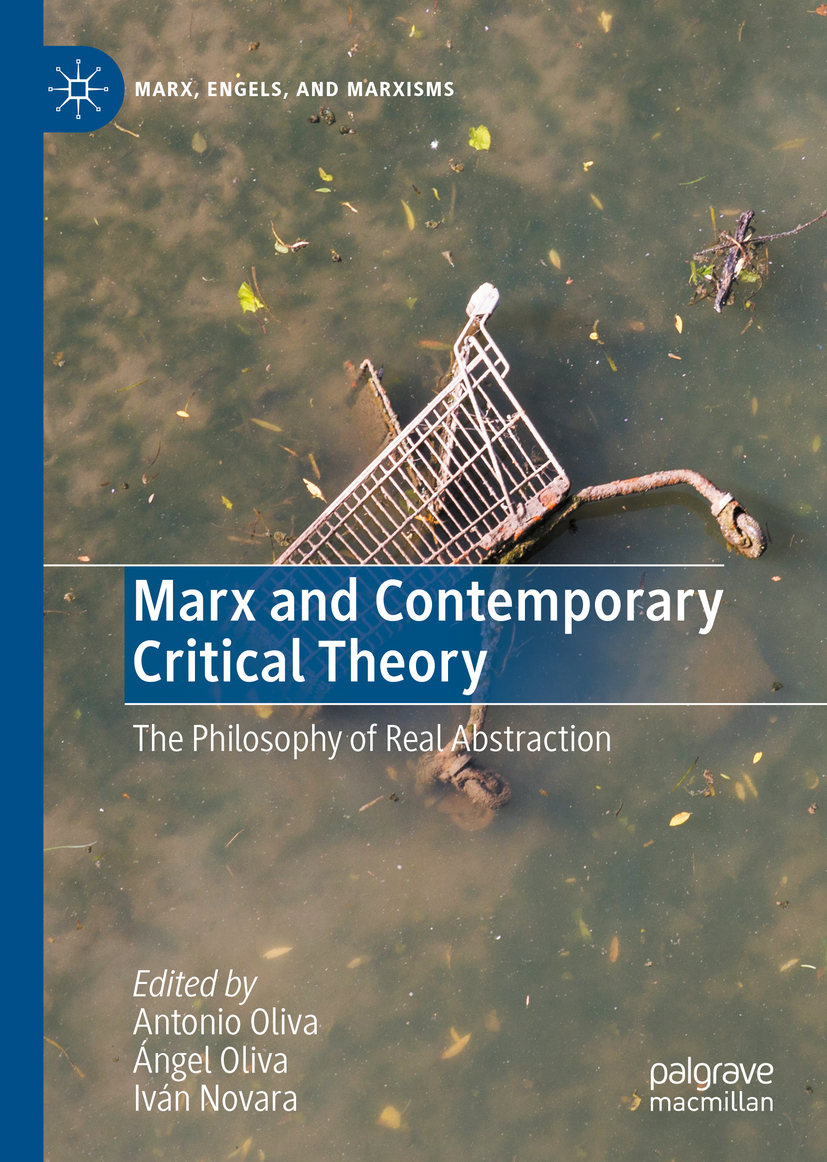
Marx and Contemporary Critical Theory This edited volume brings together an international and interdisciplinary group of scholars to explore the traces of the idea of “Real Abstraction†in Marx’s thought from the early to late writings, as well as the theoretical and practical consequences of this notion in the capitalist social system. Divided into two main parts, Part One reconstructs Marx’s notion of “Real Abstraction†and the influences of earlier thinkers (Berkley, Petty, Franklin, Feuerbach, Hegel) on his thoughts, as well as the further elaborations of this concept in later Marxist thinkers (Sohn-Rethel, Lukács, Lefebvre, Adorno and Postone). Part Two then considers the reverberations of the notion in the field of critical theory from a more abstract critique of capitalist social relations, to a more concrete understanding of historical movements. Taken together, the chapters in this volume offer a focused look at the concept of “Real Abstraction†in Marx. POLITICAL SCIENCE,History & Theory

Interrogating Modernity Interrogating Modernity returns to Hans Blumenberg's epochal The Legitimacy of the Modern Age as a springboard to interrogate questions of modernity, secularisation, technology and political legitimacy in the fields of political theology, history of ideas, political theory, art theory, history of philosophy, theology and sociology. That is, the twelve essays in this volume return to Blumenberg's work to think once more about how and why we should value the modern. Written by a group of leading international and interdisciplinary researchers, this series of responses to the question of the modern put Blumenberg into dialogue with other twentieth, and twenty-first century theorists, such as Arendt, Bloch, Derrida, Husserl, Jonas, Latour, Voegelin, Weber and many more. The result is a repositioning of his work at the heart of contemporary attempts to make sense of who we are and how we’ve got here. POLITICAL SCIENCE,History & Theory
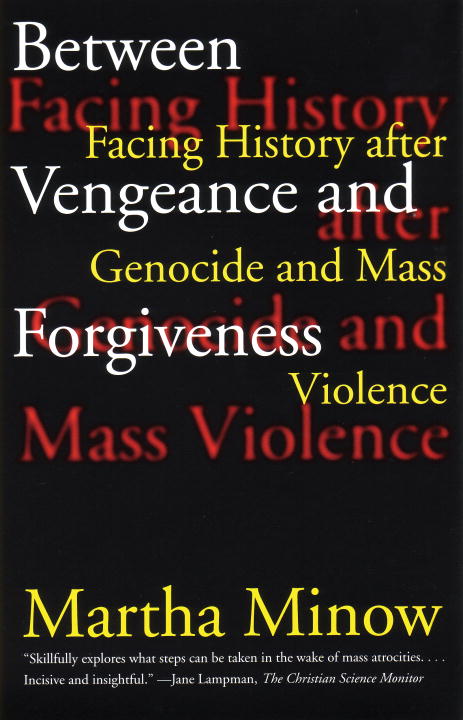
Between Vengeance and Forgiveness The rise of collective violence and genocide is the twentieth century's most terrible legacy. Martha Minow, a Harvard law professor and one of our most brilliant and humane legal minds, offers a landmark book on our attempts to heal after such large-scale tragedy. Writing with informed, searching prose of the extraordinary drama of the truth commissions in Argentina, East Germany, and most notably South Africa; war-crime prosecutions in Nuremberg and Bosnia; and reparations in America, Minow looks at the strategies and results of these riveting national experiments in justice and healing. POLITICAL SCIENCE,Human Rights

The Rise and Fall of Human Rights Explores the dialectic of cynicism and hope and the role of human rights in the production of rule in the occupied Palestinian territories. POLITICAL SCIENCE,Human Rights

The War on the Uyghurs How China is using the US-led war on terror to erase the cultural identity of its Muslim minority in the Xinjiang region Within weeks of the September 11 attacks on New York and Washington, the Chinese government warned that it faced a serious terrorist threat from its Uyghur ethnic minority, who are largely Muslim. In this explosive book, Sean Roberts reveals how China has been using the US-led global war on terror as international cover for its increasingly brutal suppression of the Uyghurs, and how the war's targeting of an undefined enemy has emboldened states around the globe to persecute ethnic minorities and severely repress domestic opposition in the name of combatting terrorism. Of the eleven million Uyghurs living in China today, more than one million are now being held in so-called reeducation camps, victims of what has become the largest program of mass detention and surveillance in the world. Roberts describes how the Chinese government successfully implicated the Uyghurs in the global terror war—despite a complete lack of evidence—and branded them as a dangerous terrorist threat with links to al-Qaeda. He argues that the reframing of Uyghur domestic dissent as international terrorism provided justification and inspiration for a systematic campaign to erase Uyghur identity, and that a nominal Uyghur militant threat only emerged after more than a decade of Chinese suppression in the name of counterterrorism—which has served to justify further state repression. A gripping and moving account of the humanitarian catastrophe that China does not want you to know about, The War on the Uyghurs draws on Roberts's own in-depth interviews with the Uyghurs, enabling their voices to be heard. POLITICAL SCIENCE,Human Rights

The Least of All Possible Evils Groundbreaking exploration of the philosophy underpinning Western humanitarian intervention The notion of a humanitarian “lesser evil” has become instrumental in justifying the West’s military adventures. It informs obscene calculations determining how much collateral damage is permissible in conflict. It determines the minimum requirements of survival imposed upon an occupied territory. As Eyal Weizman shows in this brilliant exploration of forensic architecture, this can be seen in particular in the regime imposed upon Gaza by the state of Israel. Examining the damage following the 2010 bombardment, he pieces together the systematic process of destruction, revealing the political atrocity within the debris. The way he gathers together the evidence forces us to rethink our understanding of justice and human rights in the modern world. POLITICAL SCIENCE,Human Rights
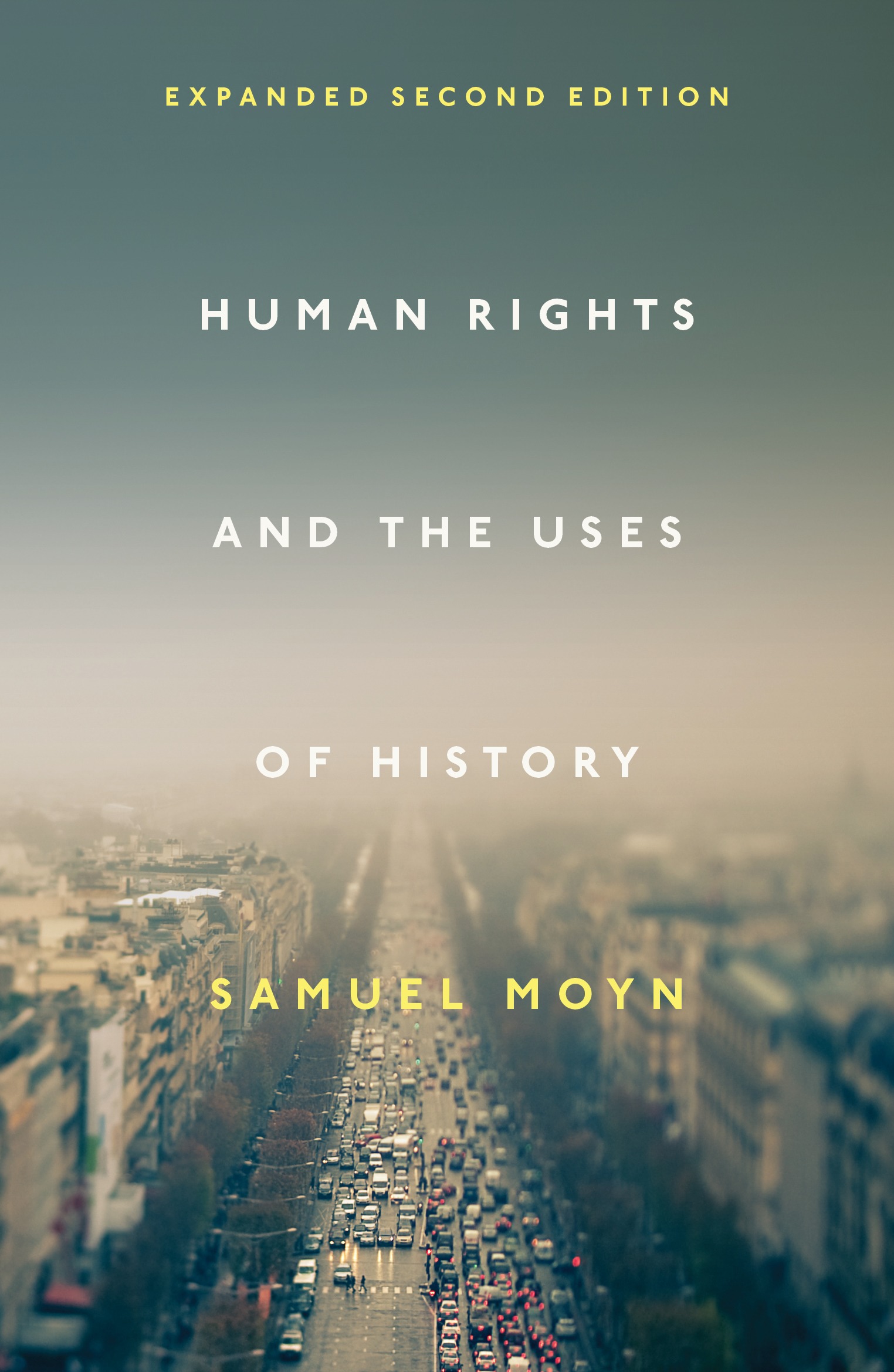
Human Rights and the Uses of History A pithy and readable challenge to the concept of human rights What are the origins of human rights? This question, rarely asked before the end of the Cold War, has in recent years become a major focus of historical and ideological strife. In this sequence of reflective and critical studies, Samuel Moyn engages with some of the leading interpreters of human rights, thinkers who have been creating a field from scratch without due reflection on the local and temporal contexts of the stories they are telling. Having staked out his owns claims about the postwar origins of human rights discourse in his acclaimed Last Utopia, Moyn, in this volume, takes issue with rival conceptions—including, especially, those that underlie justifications of humanitarian intervention. POLITICAL SCIENCE,Human Rights
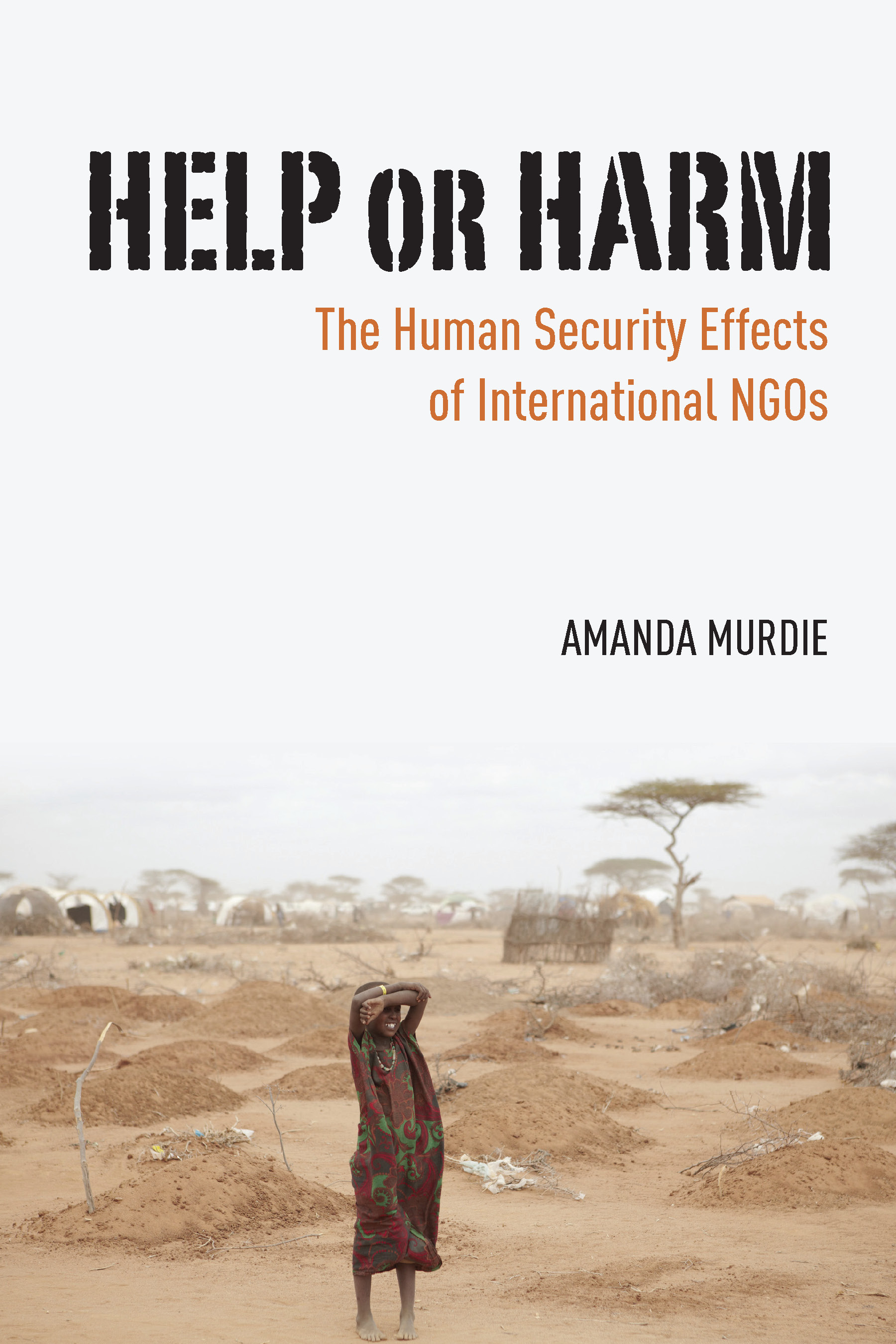
Help or Harm When do international non-governmental organizations like Oxfam or Human Rights Watch actually work? Help or Harm: The Human Security Effects of International NGOs answers this question by offering the first comprehensive framework for understanding the effects of the international non-governmental organizations working in the area of human security. Unlike much of the previous literature on INGOs within international relations, its theoretical focus includes both advocacy INGOs—such as Amnesty International or Greenpeace, whose predominant mission is getting a targeted actor to adopt a policy or behavior in line with the position of the INGO—and service INGOs—such as CARE or Oxfam, which focus mainly on goods provision. The book rigorously and logically assesses how INGOs with heterogeneous underlying motivations interact with those other actors that are critical for advocacy and service provision. This theoretical framework is tested quantitatively on a sample of over 100 countries that have exhibited imperfect human security situations since the end of the Cold War. These case-study vignettes serve as "reality checks" to the game-theoretic logic and empirical findings of the book. Amanda Murdie finds that INGOs can have powerful effects on human rights and development outcomes—although the effect of these organizations is not monolithic: differences in organizational characteristics (which reflect underlying motivations, issue-focus, and state peculiarities) condition when and where this vibrant and growing force of INGOs will be effective contributors to human security outcomes. POLITICAL SCIENCE,Human Rights
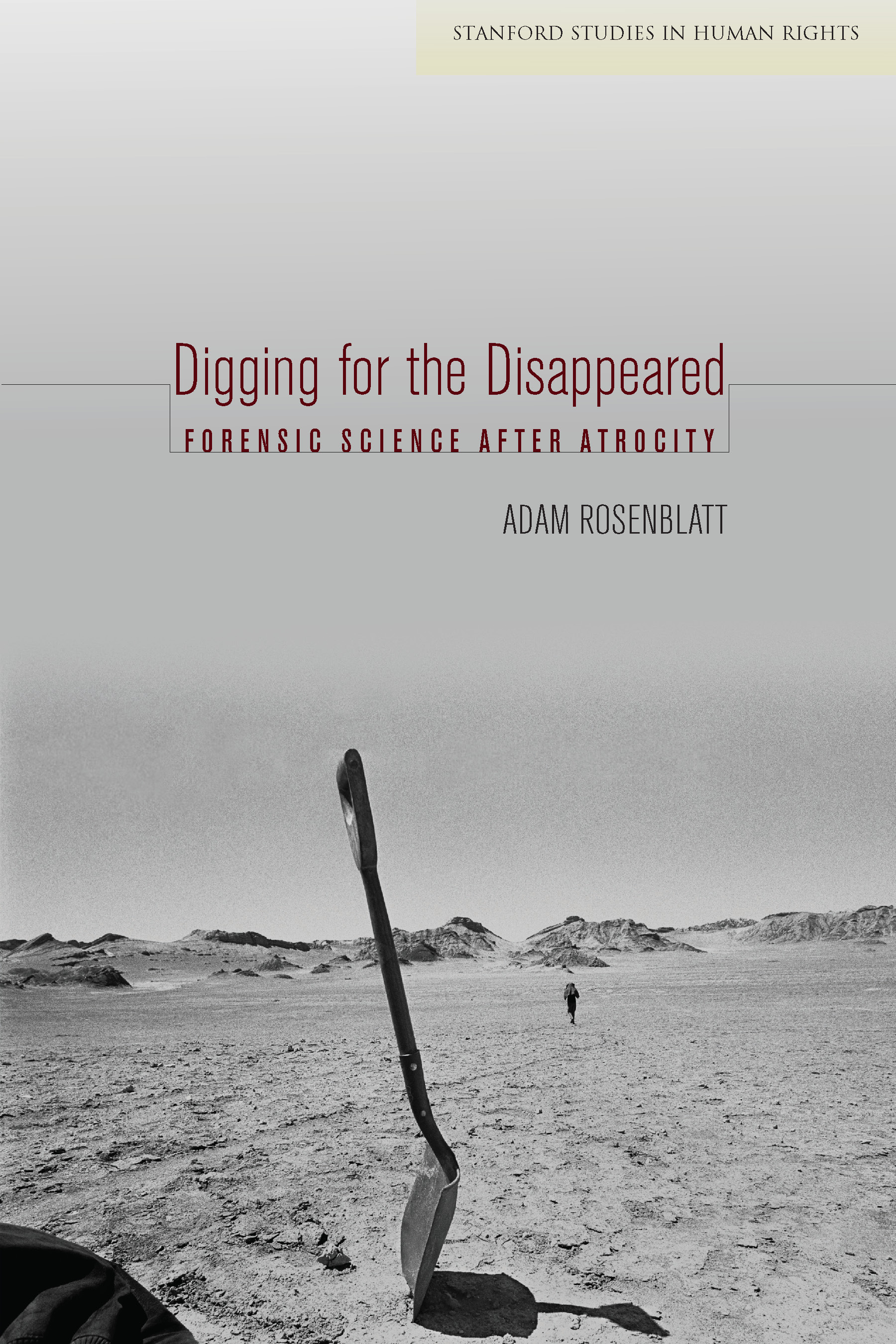
Digging for the Disappeared The mass graves from our long human history of genocide, massacres, and violent conflict form an underground map of atrocity that stretches across the planet's surface. In the past few decades, due to rapidly developing technologies and a powerful global human rights movement, the scientific study of those graves has become a standard facet of post-conflict international assistance. Digging for the Disappeared provides readers with a window into this growing but little-understood form of human rights work, including the dangers and sometimes unexpected complications that arise as evidence is gathered and the dead are named. Adam Rosenblatt examines the ethical, political, and historical foundations of the rapidly growing field of forensic investigation, from the graves of the "disappeared" in Latin America to genocides in Rwanda and the former Yugoslavia to post–Saddam Hussein Iraq. In the process, he illustrates how forensic teams strive to balance the needs of war crimes tribunals, transitional governments, and the families of the missing in post-conflict nations. Digging for the Disappeared draws on interviews with key players in the field to present a new way to analyze and value the work forensic experts do at mass graves, shifting the discussion from an exclusive focus on the rights of the living to a rigorous analysis of the care of the dead. Rosenblatt tackles these heady, hard topics in order to extend human rights scholarship into the realm of the dead and the limited but powerful forms of repair available for victims of atrocity. POLITICAL SCIENCE,Human Rights

If God Were a Human Rights Activist Human rights must be profoundly reconstructed, if not reinvented, if they are to confront successfully the challenges posed by the rise of political theologies and their rival conceptions of human dignity. POLITICAL SCIENCE,Human Rights
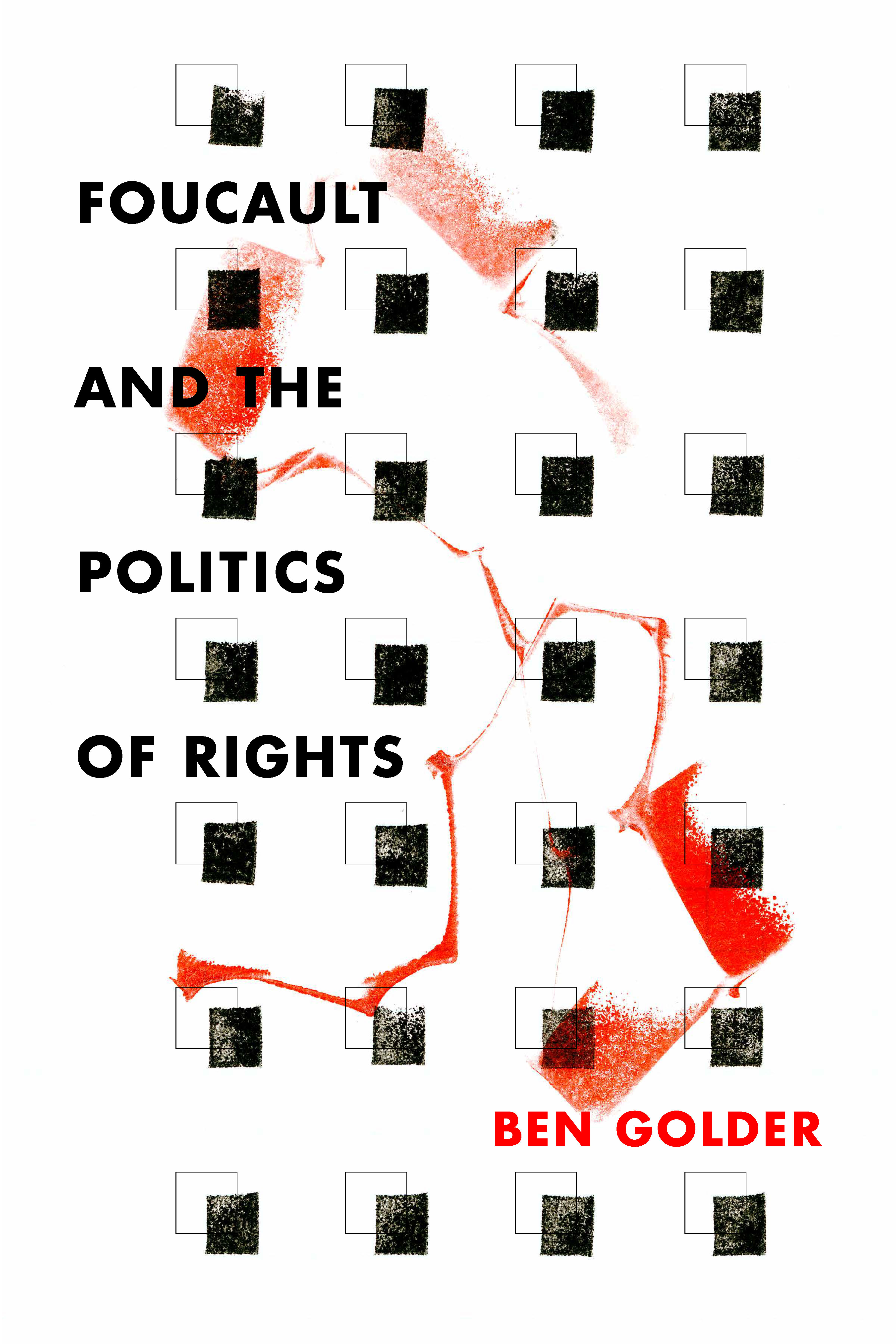
Foucault and the Politics of Rights This book proposes an original interpretation of the French philosopher Michel Foucault's late work on rights and human rights and relates this interpretation to current developments in contemporary political theory. POLITICAL SCIENCE,Human Rights

Violent Borders A major new exploration of the refugee crisis, focusing on how borders are formed and policed Forty thousand people have died trying to cross between countries in the past decade, and yet international borders only continue to harden. The United Kingdom has voted to leave the European Union; the United States elected a president who campaigned on building a wall; while elsewhere, the popularity of right-wing antimigrant nationalist political parties is surging. Reece Jones argues that the West has helped bring about the deaths of countless migrants, as states attempt to contain populations and limit access to resources and opportunities. “We may live in an era of globalization,” he writes, “but much of the world is increasingly focused on limiting the free movement of people.” In Violent Borders, Jones crosses the migrant trails of the world, documenting the billions of dollars spent on border security projects and the dire consequences for countless millions. While the poor are restricted by the lottery of birth to slum dwellings in the ailing decolonized world, the wealthy travel without constraint, exploiting pools of cheap labor and lax environmental regulations. With the growth of borders and resource enclosures, the deaths of migrants in search of a better life are intimately connected to climate change, environmental degradation, and the growth of global wealth inequality. Newly updated with a discussion of Brexit and the Trump administration. POLITICAL SCIENCE,Human Rights

Another Man's War In Another Man's War, follow Sam Childer's remarkable transformation from violent thug to a man of faith, and his ongoing battle to save children in one of the world's most lawless areas. POLITICAL SCIENCE,Human Rights

The Ethics of Interdependence This powerful book explores new global human rights duties through four case studies: mass incarceration in the United States, LGBT rights in Africa, women’s rights in Saudi Arabia, and environmental rights in China. William F. Felice presents a “human rights threshold†to identify unacceptable levels of human suffering that require urgent action. POLITICAL SCIENCE,Human Rights

Human Rights Human Rights is an introductory text that is both innovative and challenging. Its unique interdisciplinary approach invites students to think imaginatively and rigorously about one of the most important and influential political concepts of our time. Tracing the history of the concept, the book shows that there are fundamental tensions between legal, philosophical and social-scientific approaches to human rights. This analysis throws light on some of the most controversial issues in the field: Is the idea of the universality of human rights consistent with respect for cultural difference? Are there collective human rights? What are the underlying causes of human-rights violations? And why do some countries have much worse human-rights records than others? The third edition has been substantially revised and updated to take account of recent developments, including the ‘Arab Spring’, the civil war in Syria, the refugee crisis, ISIS and international terrorism, and climate change politics. Widely admired and assigned for its clarity and comprehensiveness, this book remains a ‘go-to’ text for students in the social sciences, as well as students of human-rights law who want an introduction to the non-legal aspects of their subject. POLITICAL SCIENCE,Human Rights
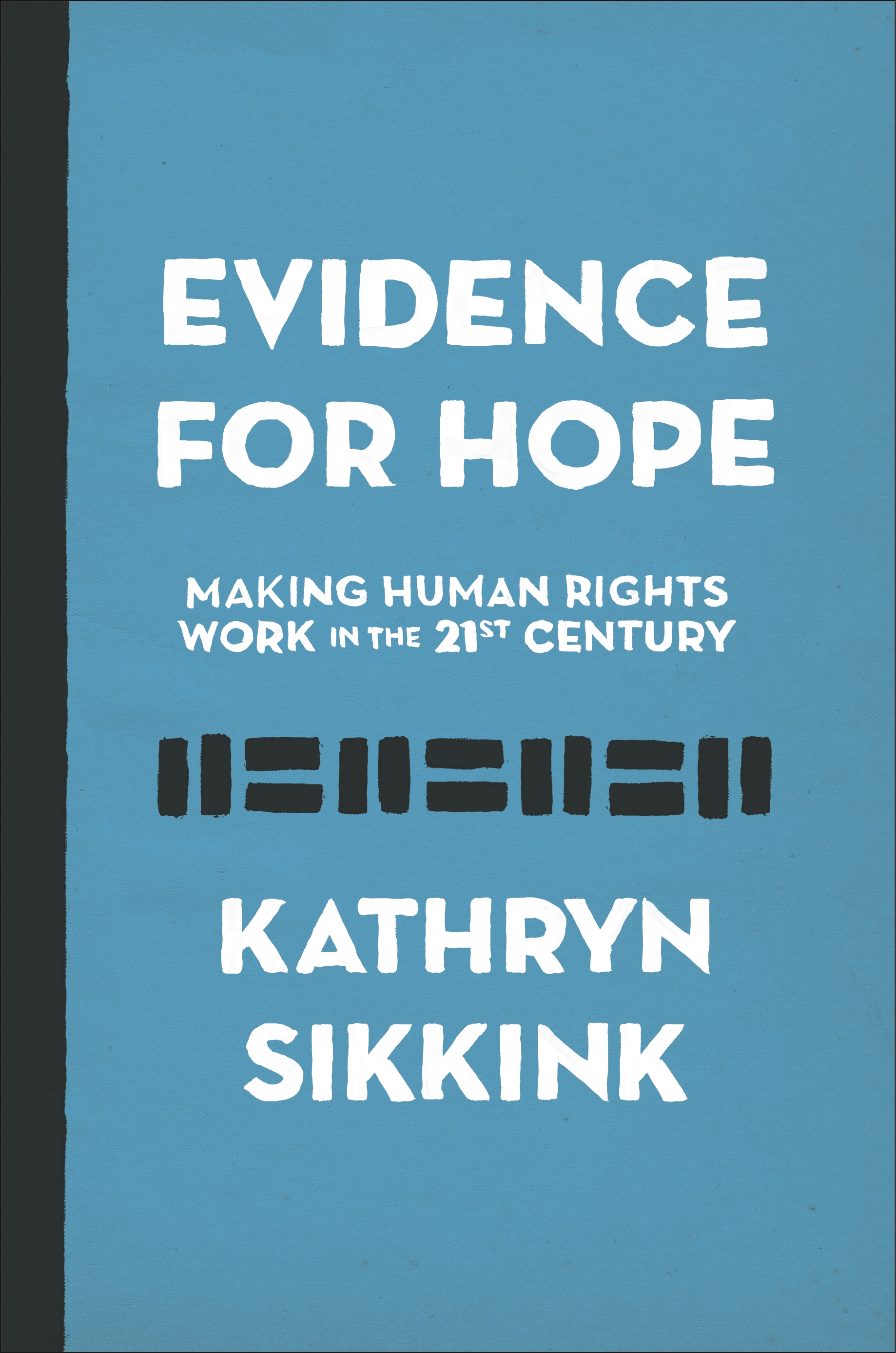
Evidence for Hope A history of the successes of the human rights movement and a case for why human rights work Evidence for Hope makes the case that, yes, human rights work. Critics may counter that the movement is in serious jeopardy or even a questionable byproduct of Western imperialism. They point out that Guantánamo is still open, the Arab Spring protests have been crushed, and governments are cracking down on NGOs everywhere. But respected human rights expert Kathryn Sikkink draws on decades of research and fieldwork to provide a rigorous rebuttal to pessimistic doubts about human rights laws and institutions. She demonstrates that change comes slowly and as the result of struggle, but in the long term, human rights movements have been vastly effective. Attacks on the human rights movement’s credibility are based on the faulty premise that human rights ideas emerged in North America and Europe and were imposed on developing southern nations. Starting in the 1940s, Latin American leaders and activists were actually early advocates for the international protection of human rights. Sikkink shows that activists and scholars disagree about the efficacy of human rights because they use different yardsticks to measure progress. Comparing the present to the past, she shows that genocide and violence against civilians have declined over time, while access to healthcare and education has increased dramatically. Cognitive and news biases contribute to pervasive cynicism, but Sikkink’s investigation into past and current trends indicates that human rights is not in its twilight. Instead, this is a period of vibrant activism that has made impressive improvements in human well-being. Exploring the strategies that have led to real humanitarian gains since the middle of the twentieth century, Evidence for Hope looks at how these essential advances can be supported and sustained for decades to come. POLITICAL SCIENCE,Human Rights

Bureaucratic Intimacies Human rights are politically fraught in Turkey, provoking suspicion and scrutiny among government workers for their anti-establishment left-wing connotations. Nevertheless, with eyes worldwide trained on Turkish politics, and with accession to the European Union underway, Turkey's human rights record remains a key indicator of its governmental legitimacy. Bureaucratic Intimacies shows how government workers encounter human rights rhetoric through training programs and articulates the perils and promises of these encounters for the subjects and objects of Turkish governance. Drawing on years of participant observation in programs for police officers, judges and prosecutors, healthcare workers, and prison personnel, Elif M. Babül argues that the accession process does not always advance human rights. In casting rights as requirements for expertise and professionalism, training programs strip human rights of their radical valences, disassociating them from their political meanings within grassroots movements. Translation of human rights into a tool of good governance leads to competing understandings of what human rights should do, not necessarily to liberal, transparent, and accountable governmental practices. And even as translation renders human rights relevant for the everyday practices of government workers, it ultimately comes at a cost to the politics of human rights in Turkey. POLITICAL SCIENCE,Human Rights
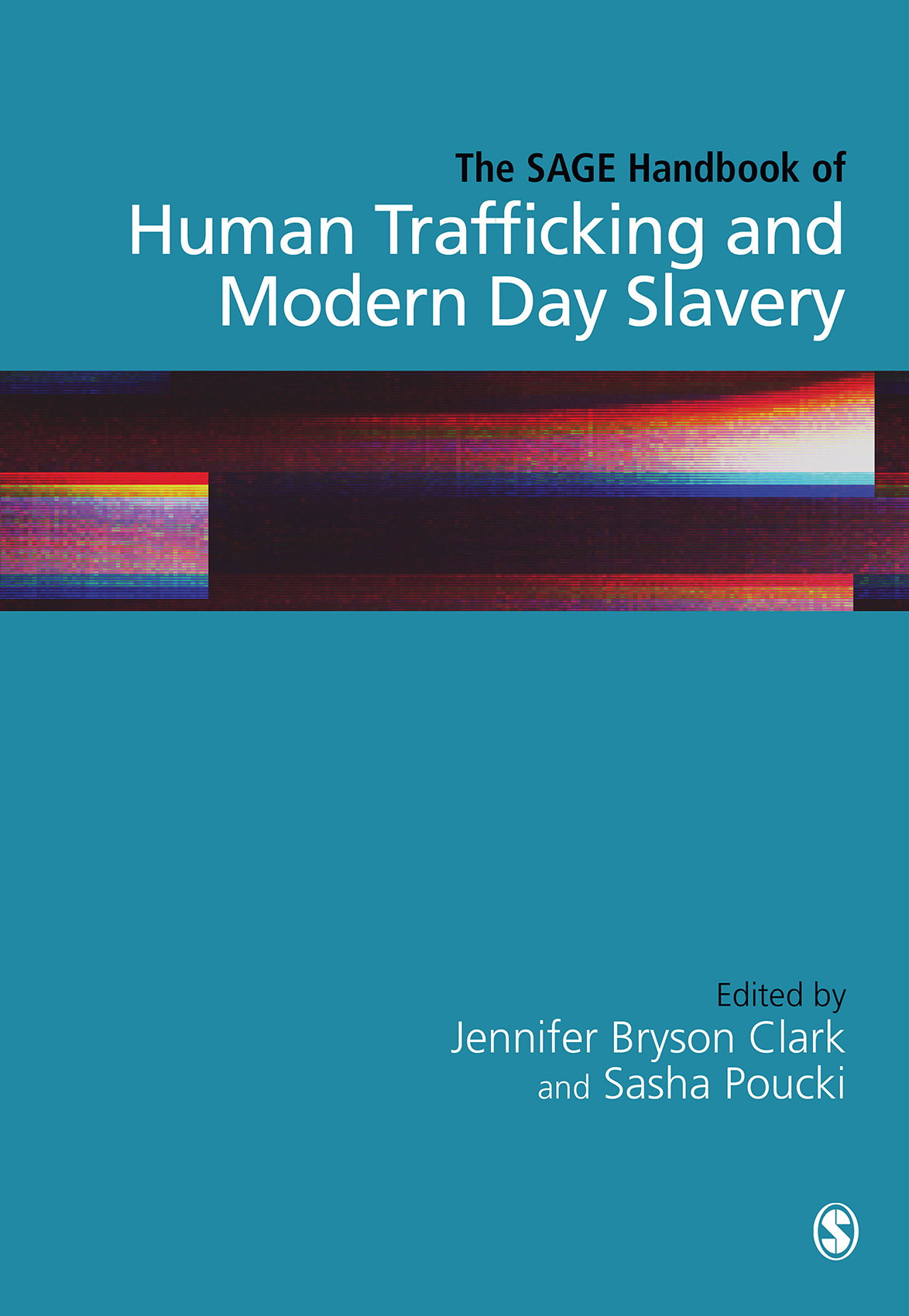
The SAGE Handbook of Human Trafficking and Modern Day Slavery The SAGE Handbook of Human Trafficking and Modern-Day Slavery provides a comprehensive, interdisciplinary and global look at the diverse issues surrounding human trafficking and slavery in the post-1945 environment. POLITICAL SCIENCE,Human Rights

Development-induced Displacement and Human Rights in Africa Within the context of the 2009 Kampala Convention, this book examines how a balance can be struck between the imperative of development projects and the rights of persons likely to be displaced in Africa. Following independence, many African states embarked on large-scale development projects such as dams, urban renewal and extraction of natural resources and have had to grapple with how to protect displaced communities while implementing development projects. These projects were considered a panacea for Africa’s development and the economic interests of the majority were often considered over and above the interests of the minority of people who were displaced by these projects .This book examines how a balance can be struck between the imperative of development and the rights of displaced persons within the context of the African Union Convention on the Protection and Assistance of Internally Displaced Persons in Africa (the Kampala Convention). Romola Adeola analyses the obligations that are placed on African states by the Kampala Convention in the context of development-induced displacement. This book will be of interest to scholars of human rights law, forced migration, African Studies and development. POLITICAL SCIENCE,Human Rights
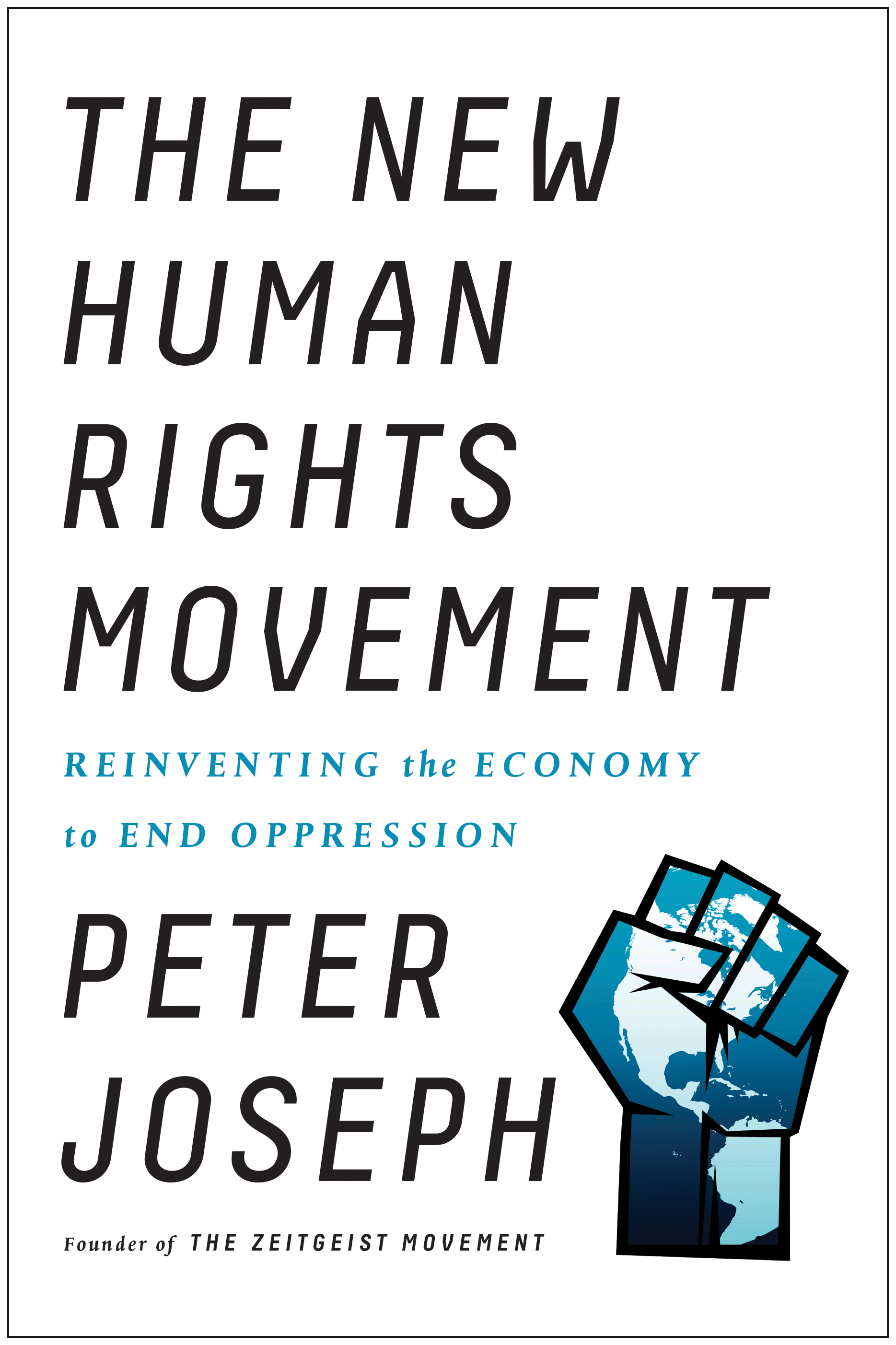
The New Human Rights Movement Society is broken. We can design our way to a better one. In our interconnected world, self-interest and social-interest are rapidly becoming indistinguishable. If current negative trajectories remain, including growing climate destabilization, biodiversity loss, and economic inequality, an impending future of ecological collapse and societal destabilization will make personal success†virtually meaningless. Yet our broken social system incentivizes behavior that will only make our problems worse. If true human rights progress is to be achieved today, it is time we dig deeperrethinking the very foundation of our social system. In this engaging, important work, Peter Joseph, founder of the world’s largest grassroots social movementThe Zeitgeist Movementdraws from economics, history, philosophy, and modern public-health research to present a bold case for rethinking activism in the 21st century. Arguing against the long-standing narrative of universal scarcity and other pervasive myths that defend the current state of affairs, The New Human Rights Movement illuminates the structural causes of poverty, social oppression, and the ongoing degradation of public health, and ultimately presents the case for an updated economic approach. Joseph explores the potential of this grand shift and how we can design our way to a world where the human family has become truly sustainable. The New Human Rights Movement reveals the critical importance of a unified activism working to overcome the inherent injustice of our system. This book warns against what is in store if we continue to ignore the flaws of our socioeconomic approach, while also revealing the bright and expansive future possible if we succeed. Will you join the movement? POLITICAL SCIENCE,Human Rights

Human Rights Without Democracy? Do Human Rights truly serve the people? Should citizens themselves decide democratically of what those rights consist? Or is it a decision for experts and the courts? Gret Haller argues that Human Rights must be established democratically. Drawing on the works of political philosophers from John Locke to Immanuel Kant, she explains why, from a philosophical point of view, liberty and equality need not be mutually exclusive. She outlines the history of the concept of Human Rights, shedding light on the historical development of factual rights, and compares how Human Rights are understood in the United States in contrast to Great Britain and Continental Europe, uncovering vast differences. The end of the Cold War presented a challenge to reexamine equality as being constitutive of freedom, yet the West has not seized this opportunity and instead allows so-called experts to define Human Rights based on individual cases. Ultimately, the highest courts revise political decisions and thereby discourage participation in the democratic shaping of political will. POLITICAL SCIENCE,Human Rights
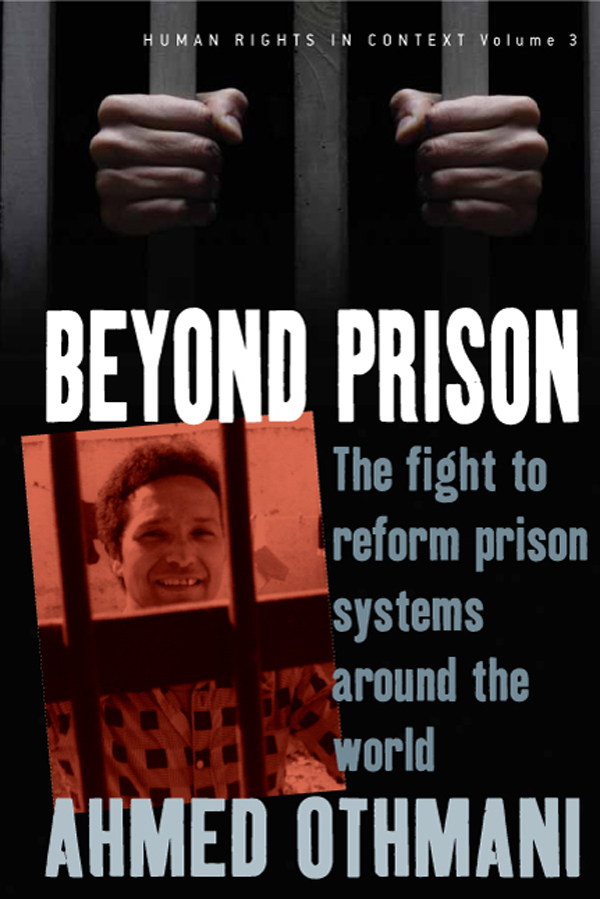
Beyond Prison “This is an exceptional personal testimony and story of achievement – Ahmed Othmani tells of his own appalling treatment when in detention and how it informed and inspired a lifetime vocation to struggle for the rights of all prisoners everywhere. As the story demonstrates, Othmani is one of those rare individuals who moved from passion and conviction to effective action – he was responsible for the establishment of one of the world’s most reliable and mature human rights organizations, in the field of penal reform, Penal Reform International (PRI). His untimely death in Morocco in 2004 deprived the cause of a passionate advocate, but the work goes on.†[From the Preface] POLITICAL SCIENCE,Human Rights

Empire of Humanity From the 19th-century abolitionist movement to today's NGOs, a critical account of humanitarianism in world politics. POLITICAL SCIENCE,Human Rights
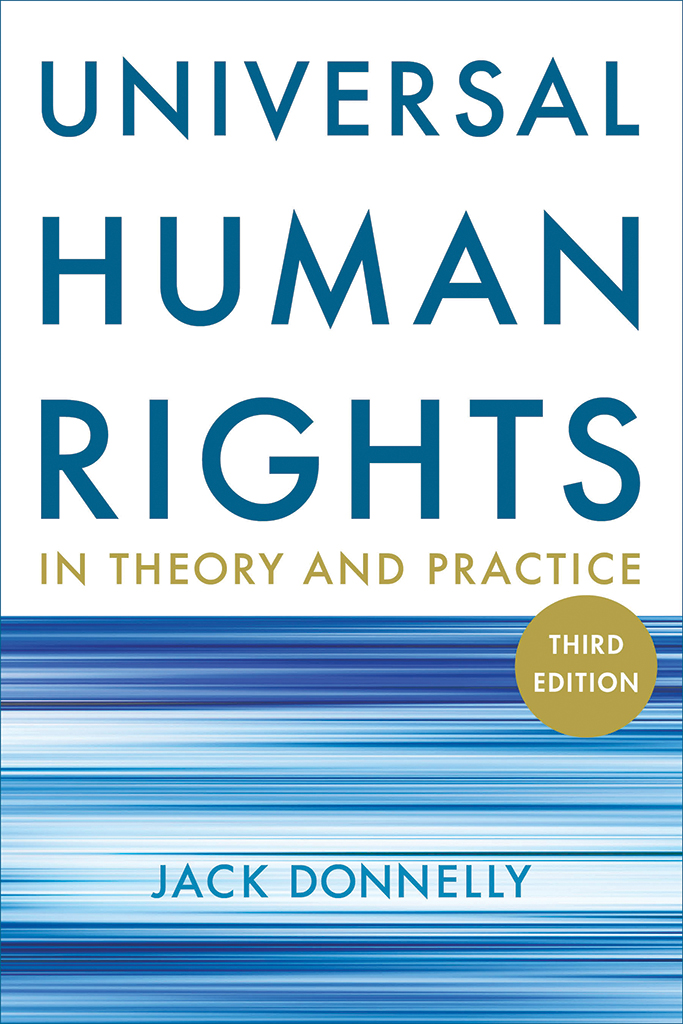
Universal Human Rights in Theory and Practice In the third edition of his classic work, revised extensively and updated to include recent developments on the international scene, Jack Donnelly explains and defends a richly interdisciplinary account of human rights as universal rights. He shows that any conception of human rights—and the idea of human rights itself—is historically specific and contingent. Since publication of the first edition in 1989, Universal Human Rights in Theory and Practice has justified Donnelly’s claim that "conceptual clarity, the fruit of sound theory, can facilitate action. At the very least it can help to unmask the arguments of dictators and their allies." POLITICAL SCIENCE,Human Rights
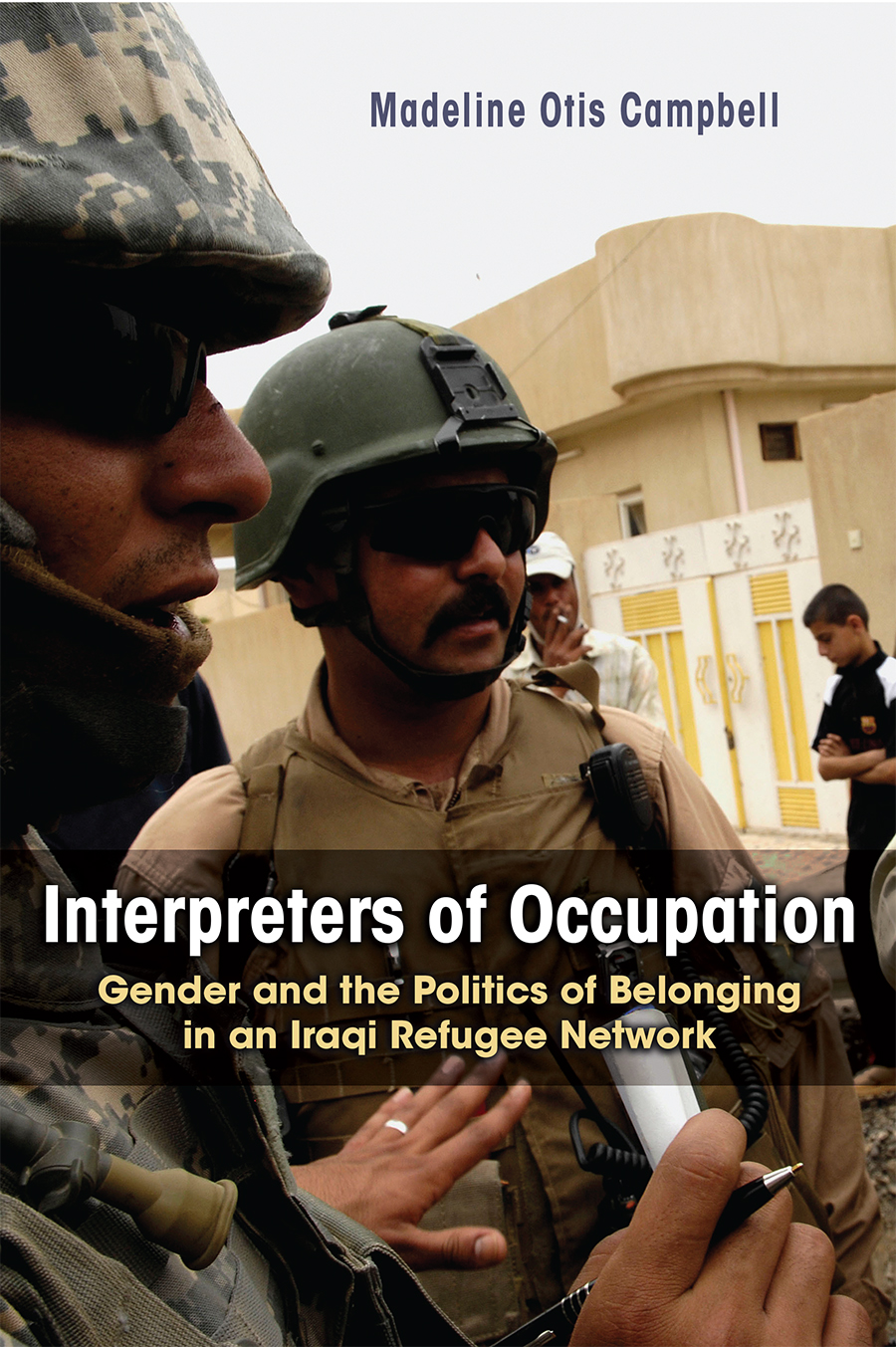
Interpreters of Occupation During the Iraq War, thousands of young Baghdadis worked as interpreters for US troops, becoming the front line of the so-called War on Terror. Deployed by the military as linguistic as well as cultural interpreters—translating the "human terrain" of Iraq—members of this network urgently honed identification strategies amid suspicion from US forces, fellow Iraqis, and, not least of all, one another. In Interpreters of Occupation, Campbell traces the experiences of twelve individuals from their young adulthood as members of the last Ba’thist generation, to their work as interpreters, through their navigation of the US immigration pipeline, and finally to their resettlement in the United States. Throughout, Campbell considers how these men and women grappled with issues of belonging and betrayal, both on the battlefield in Iraq and in the US-based diaspora.A nuanced and richly detailed ethnography, Interpreters of Occupation gives voice to a generation of US allies through their diverse and vividly rendered life histories. In the face of what some considered a national betrayal in Iraq and their experiences of otherness within the United States, interpreters negotiate what it means to belong to a diasporic community in flux. POLITICAL SCIENCE,Human Rights
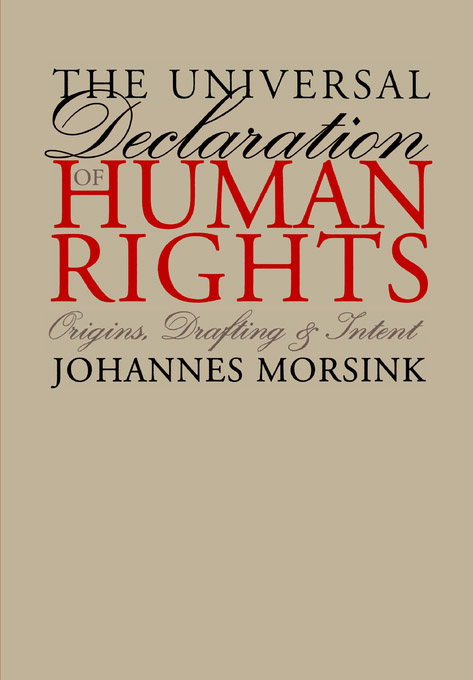
The Universal Declaration of Human Rights "A splendid volume . . . fused with political and philosophical insight into the fundamental concepts underlying the Declaration."—American Journal of International Law POLITICAL SCIENCE,Human Rights

Human Rights in Latin America This textbook gives a comprehensive overview of the human rights issues facing more than half of the Western Hemisphere. Cardenas synthesizes a large volume of research and incorporates primary documents, wide-ranging cases, images, and supplementary student resources, to explore basic themes of terror and hope. POLITICAL SCIENCE,Human Rights
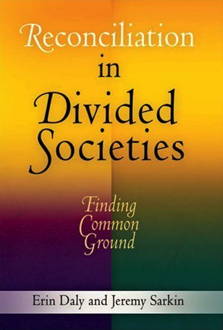
Reconciliation in Divided Societies As nations struggling to heal wounds of civil war and atrocity turn toward the model of reconciliation, Reconciliation in Divided Societies takes a systematic look at the political dimensions of this international phenomenon. POLITICAL SCIENCE,Human Rights

Crimes of Peace In Crimes of Peace, Maurizio Albahari investigates why the Mediterranean Sea is the world's deadliest border, and what alternatives might improve this state of affairs. Albahari transforms abstract statistics into names and narratives that place the responsibility for the Mediterranean migration crisis in the heart of liberal democracy. POLITICAL SCIENCE,Human Rights

Christian Human Rights In Christian Human Rights, Samuel Moyn asserts that the rise of human rights after World War II was prefigured and inspired by a defense of the dignity of the human person that first arose in Christian churches and religious thought in the years just prior to the outbreak of the war. POLITICAL SCIENCE,Human Rights

Raphael Lemkin and the Concept of Genocide Raphaël Lemkin was one of the twentieth century's most influential human rights figures, coining the word "genocide" in 1942 and working to embed the idea into international law. This book sheds new light on the concept of genocide, exploring the connection between Lemkin's philosophical writings, juridical works, and politics. POLITICAL SCIENCE,Human Rights

U.S. Foreign Policy and Muslim Women's Human Rights U.S. Foreign Policy and Muslim Women's Human Rights explores the integration of American concerns about women's human rights into U.S. policy toward Islamic countries since 1979, reframing U.S.-Islamic relations and challenging assumptions about the drivers of American foreign policy. POLITICAL SCIENCE,Human Rights
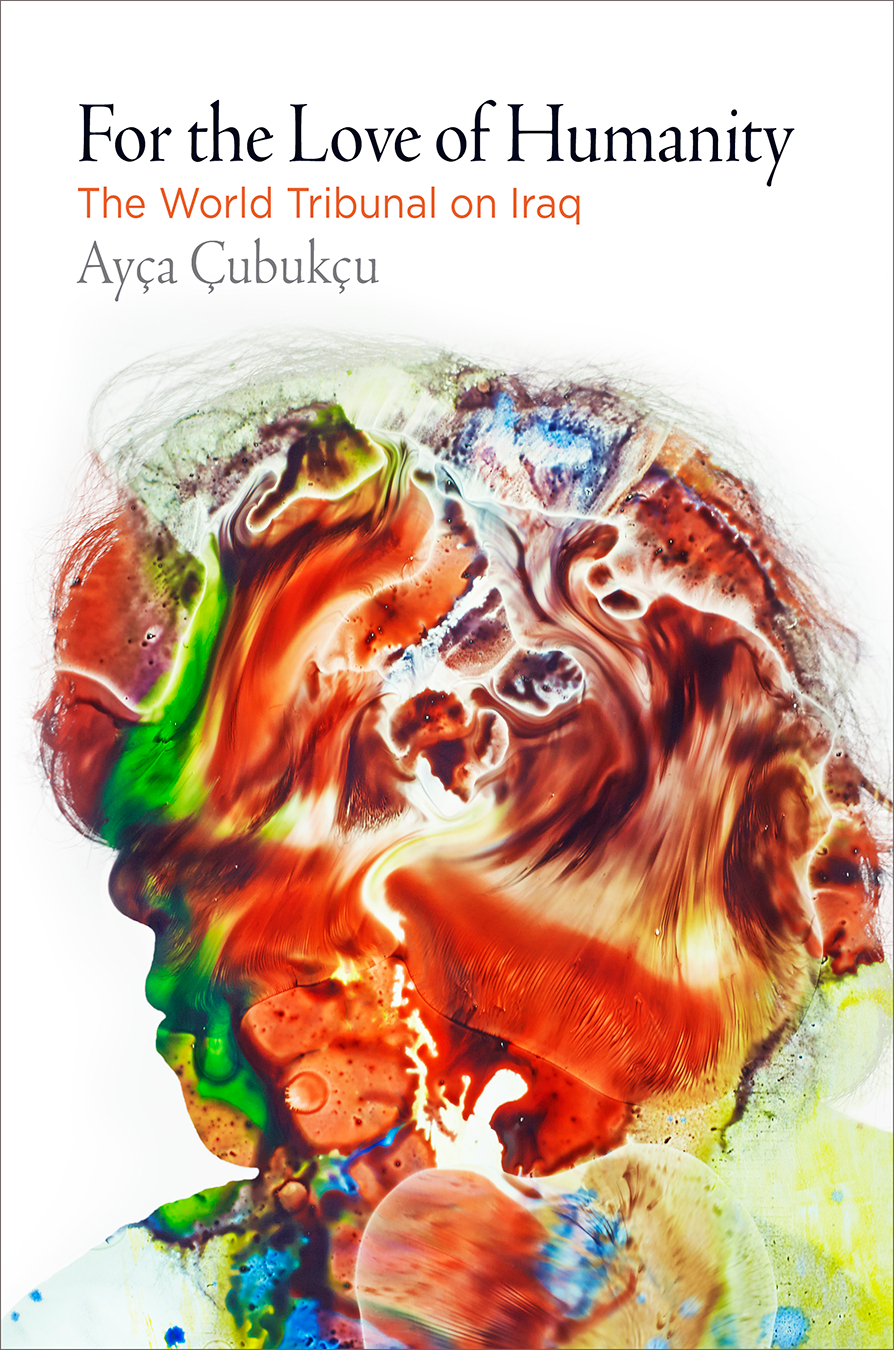
For the Love of Humanity Based on two years of fieldwork with the transnational network of antiwar activists who constituted the World Tribunal on Iraq, For the Love of Humanity addresses the contemporary challenges and ambiguities of forging global solidarity through an anti-imperialist politics of human rights and international law. POLITICAL SCIENCE,Human Rights

Crimes Against Humanity How we can stop the world's worst atrocities Murder, extermination, enslavement, ethnic cleansing, rape, and torture: all these actions constitute ‘crimes against humanity’ when carried out in a widespread or systematic way. And unfortunately, as is painfully apparent in the popular media every day, the international community still has a long way to go in eradicating such atrocities. In this compelling introduction, Adam Jones outlines the history and current extent of key crimes committed against humanity, and highlights the efforts of popular movements to suppress them. Using examples ranging from the genocide in Darfur and Rwanda and the sex trade of Eastern Europe to the use of torture on American detainees, Jones explores the progress already made in toughening international law, and the current stumbling blocks which prevent full compliance with it. Coherent and revealing, Crimes Against Humanity: A Beginner’s Guide is essential for anyone interested in the well-being of humanity and its future. POLITICAL SCIENCE,Human Rights
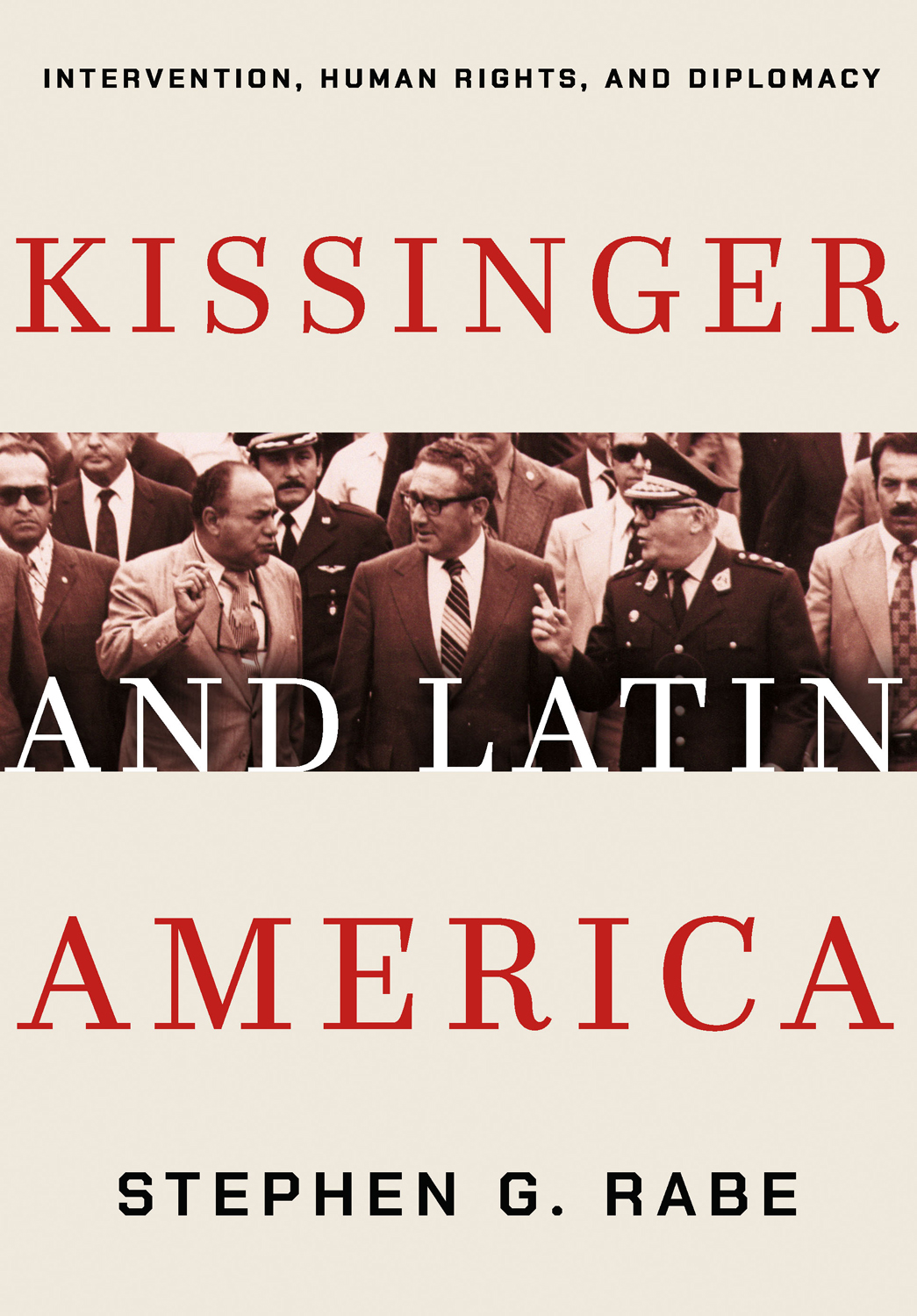
Kissinger and Latin America In Kissinger and Latin America, Stephen G. Rabe analyzes U.S. policies toward Latin America during a critical period of the Cold War. Except for the issue of Chile under Salvador Allende, historians have largely ignored inter-American relations during the presidencies of Richard M. Nixon and Gerald R. Ford. Rabe also offers a way of adding to and challenging the prevailing historiography on one of the most preeminent policymakers in the history of U.S. foreign relations. Scholarly studies on Henry Kissinger and his policies between 1969 and 1977 have tended to survey Kissinger's approach to the world, with an emphasis on initiatives toward the Soviet Union and the People's Republic of China and the struggle to extricate the United States from the Vietnam conflict. Kissinger and Latin America offers something new—analyzing U.S. policies toward a distinct region of the world during Kissinger's career as national security adviser and secretary of state. Rabe further challenges the notion that Henry Kissinger dismissed relations with the southern neighbors. The energetic Kissinger devoted more time and effort to Latin America than any of his predecessors—or successors—who served as the national security adviser or secretary of state during the Cold War era. He waged war against Salvador Allende and successfully destabilized a government in Bolivia. He resolved nettlesome issues with Mexico, Peru, Ecuador, and Venezuela. He launched critical initiatives with Panama and Cuba. Kissinger also bolstered and coddled murderous military dictators who trampled on basic human rights. South American military dictators whom Kissinger favored committed international terrorism in Europe and the Western Hemisphere. POLITICAL SCIENCE,Human Rights

How to Destroy America in Three Easy Steps A growing number of Americans want to tear down what it’s taken us 250 years to build—and they’ll start by canceling our shared history, ideals, and culture. Traditional areas of civic agreement are vanishing. We can’t agree on what makes America special. We can’t even agree that America is special. We’re coming to the point that we can’t even agree what the word America itself means. “Disintegrationists†say we’re stronger together, but their assault on America’s history, philosophy, and culture will only tear us apart. Who are the disintegrationists? From Howard Zinn’s A People’s History of the United States to the New York Times’ 1619 project, many modern analyses view American history through the lens of competing oppressions, a racist and corrupt experiment from the very beginning. They see American philosophy as a lie – beautiful words pasted over a thoroughly rotted system. They see America’s culture of rights as a façade that merely reinforces traditional hierarchies of power, instead of being the only culture that guarantees freedom for individuals. Disintegrationist attacks on the values that built our nation are insidious because they replace each foundational belief, from the rights to free speech and self-defense to the importance of marriage and faith communities, with nothing more than an increased reliance on the government. This twisted disintegrationist vision replaces the traditional “unionist†understanding that all Americans are united in a shared striving toward the perfection of universal ideals. How to Destroy America in Three Easy Steps shows that to be a cohesive nation we have to uphold foundational truths about ourselves, our history, and reality itself—to be unionists instead of disintegrationists. Shapiro offers a vital warning that if we don’t recover these shared truths, our future—our union—as a great country is threatened with destruction. POLITICAL SCIENCE,Human Rights
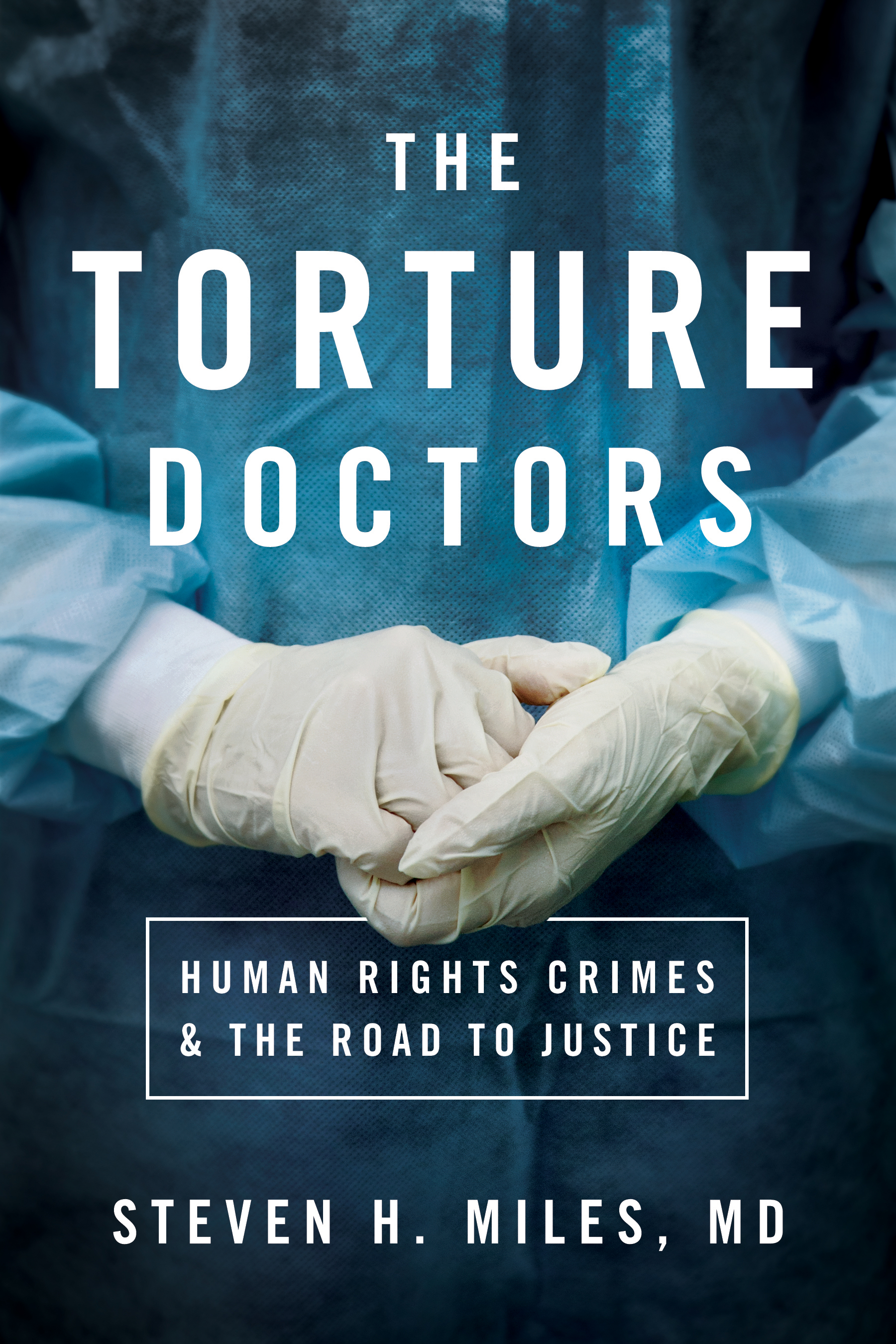
The Torture Doctors Torture doctors administer and invent techniques to inflict pain and suffering without leaving scars.Their knowledge of the body and its breaking points and their credible authority over death certificates and medical records make them powerful and elusive perpetrators of the crime of torture. In The Torture Doctors, Steven H. Miles fearlessly explores who these physicians are, what they do, how they escape justice, and what can be done to hold them accountable. At least one hundred countries employ torture doctors, including both dictatorships and democracies. While torture doctors mostly act with impunity—protected by governments, medical associations, and licensing boards—Miles shows that a movement has begun to hold these doctors accountable and to return them to their proper role as promoters of health and human rights. Miles’s groundbreaking portrayal exposes the thinking and psychology of these doctors, and his investigation points to how the international human rights community and the medical community can come together to end these atrocities. POLITICAL SCIENCE,Human Rights
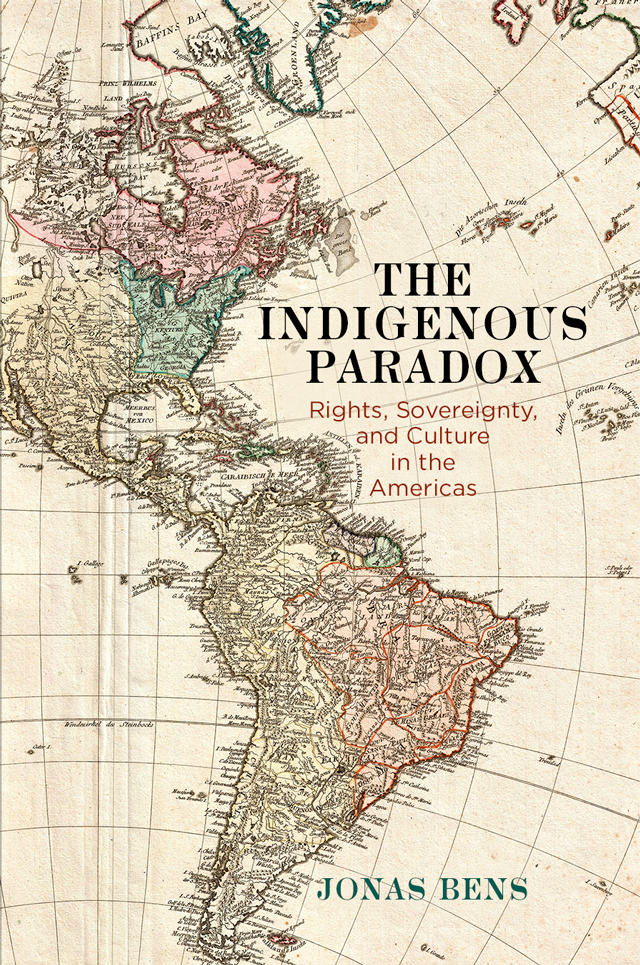
The Indigenous Paradox Indigeneity contains a paradox: indigenous communities are incorporated into and separated from the legal system of the postcolonial nation state. The Indigenous Paradox explores indigenous rights cases from north and south America in order to shed light on issues of shared sovereignty, multiculturalism, and legal pluralism. POLITICAL SCIENCE,Human Rights

A Question of Commitment In this essay collection, scholars assess the extent to which children’s rights have been incorporated into Canadian policy and law, drawing conclusions about the status of children in Canada. Overall, many challenges remain on the pathway to full recognition of children as subjects and bearers of rights in this country. POLITICAL SCIENCE,Human Rights

HIV-AIDs, NGOs And Human Rights Non-Governmental Organisations (NGOs) are becoming increasingly important in the field of development. NGOs are a very important link between people at the grassroots, civil society and the state. They are diverse both in terms of organisational form, structure and culture and in terms of the issues they cover. Their involvement is not only seen in the implementation of governmental programmes but also in the process of formulation of public policies, and even in the enforcement of social legislation. The purpose of this book is to explore the efforts of non-governmental organisations in combating the global HIV/AIDS crisis. Despite of the depth of literature already in existence concerning the benefits and effectiveness of NGOs in the health field, research in developing and evaluating the full potential and effectiveness of the transfer of HIV prevention intervention models from the research arena to NGOs in developing countries with high HIV incidence is still in its infancy. NGOs working in tandem with international, national and local public health organisations will allow HIV prevention research advances to better benefit the global fight against HIV/AIDS. This book is a modest attempt to discuss all these issues. It intends to focus on NGO, Globalization and Tribes in India and abroad. The case studies of various NGOs reflect the initiatives, programme execution strategies, successes and challenges faced by them in combating HIV/AIDS. POLITICAL SCIENCE,Human Rights

Juvenile Rights, Child Rights And Women Rights The book examines the linkages between children's and women's rights in the context of global human right provision. The paper demonstrates how reading these conventions together can enrich the promotion and protection of children's and women's rights. The book highlights aspects of the human rights based approach that are particularly relevant for the achievement of children's and women's rights. The book also focuses on specific programmatic areas, providing the relevant provisions in various countries, and concrete recommendations. The book provides an overview of human rights based approaches to development as a strategy for the advancement of children's and women's rights. POLITICAL SCIENCE,Human Rights

Human Shields A chilling global history of the human shield phenomenon. From Syrian civilians locked in iron cages to veterans joining peaceful indigenous water protectors at the Standing Rock Sioux Reservation, from Sri Lanka to Iraq and from Yemen to the United States, human beings have been used as shields for protection, coercion, or deterrence. Over the past decade, human shields have also appeared with increasing frequency in antinuclear struggles, civil and environmental protests, and even computer games. The phenomenon, however, is by no means a new one. Describing the use of human shields in key historical and contemporary moments across the globe, Neve Gordon and Nicola Perugini demonstrate how the increasing weaponization of human beings has made the position of civilians trapped in theaters of violence more precarious and their lives more expendable. They show how the law facilitates the use of lethal violence against vulnerable people while portraying it as humane, but they also reveal how people can and do use their own vulnerability to resist violence and denounce forms of dehumanization. Ultimately, Human Shields unsettles our common ethical assumptions about violence and the law and urges us to imagine entirely new forms of humane politics. POLITICAL SCIENCE,Human Rights
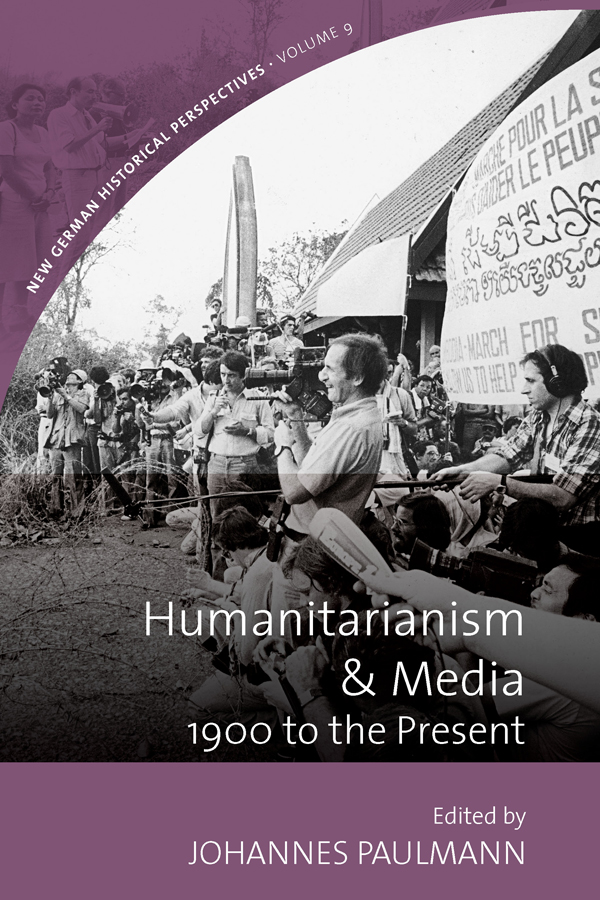
Humanitarianism and Media From Christian missionary publications to the media strategies employed by today’s NGOs, this interdisciplinary collection explores the entangled histories of humanitarianism and media. It traces the emergence of humanitarian imagery in the West and investigates how the meanings of suffering and aid have been constructed in a period of evolving mass communication, demonstrating the extent to which many seemingly new phenomena in fact have long historical legacies. Ultimately, the critical histories collected here help to challenge existing asymmetries and help those who advocate a new cosmopolitan consciousness recognizing the dignity and rights of others. POLITICAL SCIENCE,Human Rights
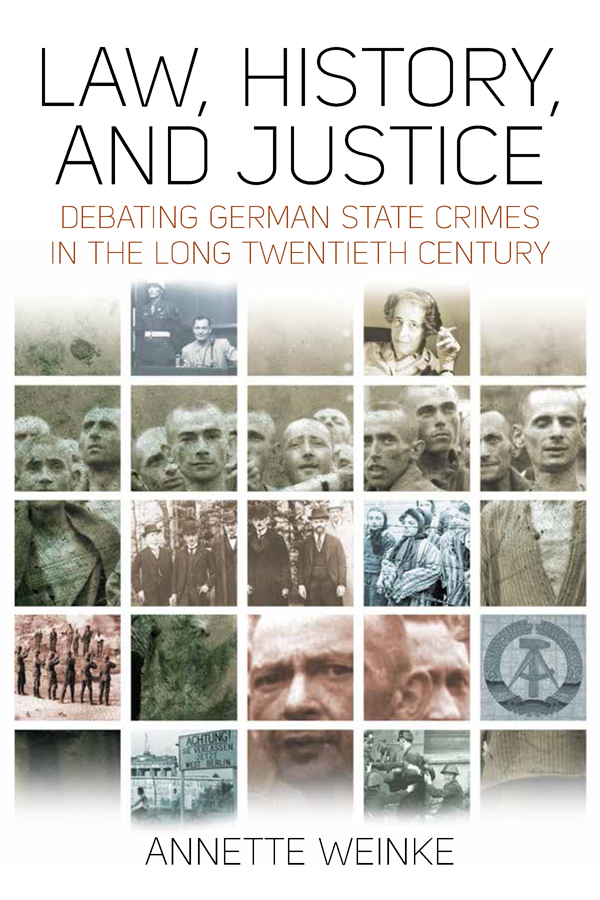
Law, History, and Justice Since the nineteenth century, the development of international humanitarian law has been marked by complex entanglements of legal theory, historical trauma, criminal prosecution, historiography, and politics. All of these factors have played a role in changing views on the applicability of international law and human-rights ideas to state-organized violence, which in turn have been largely driven by transnational responses to German state crimes. Here, Annette Weinke gives a groundbreaking long-term history of the political, legal and academic debates concerning German state and mass violence in the First World War, during the National Socialist era and the Holocaust, and under the GDR. POLITICAL SCIENCE,Human Rights

The Brazilian Truth Commission Bringing together some of the world’s leading scholars, practitioners, and human-rights activists, this groundbreaking volume provides the first systematic analysis of the 2012–2014 Brazilian National Truth Commission. While attentive to the inquiry’s local and national dimensions, it offers an illuminating transnational perspective that considers the Commission’s Latin American regional context and relates it to global efforts for human rights accountability, contributing to a more general and critical reassessment of truth commissions from a variety of viewpoints. POLITICAL SCIENCE,Human Rights
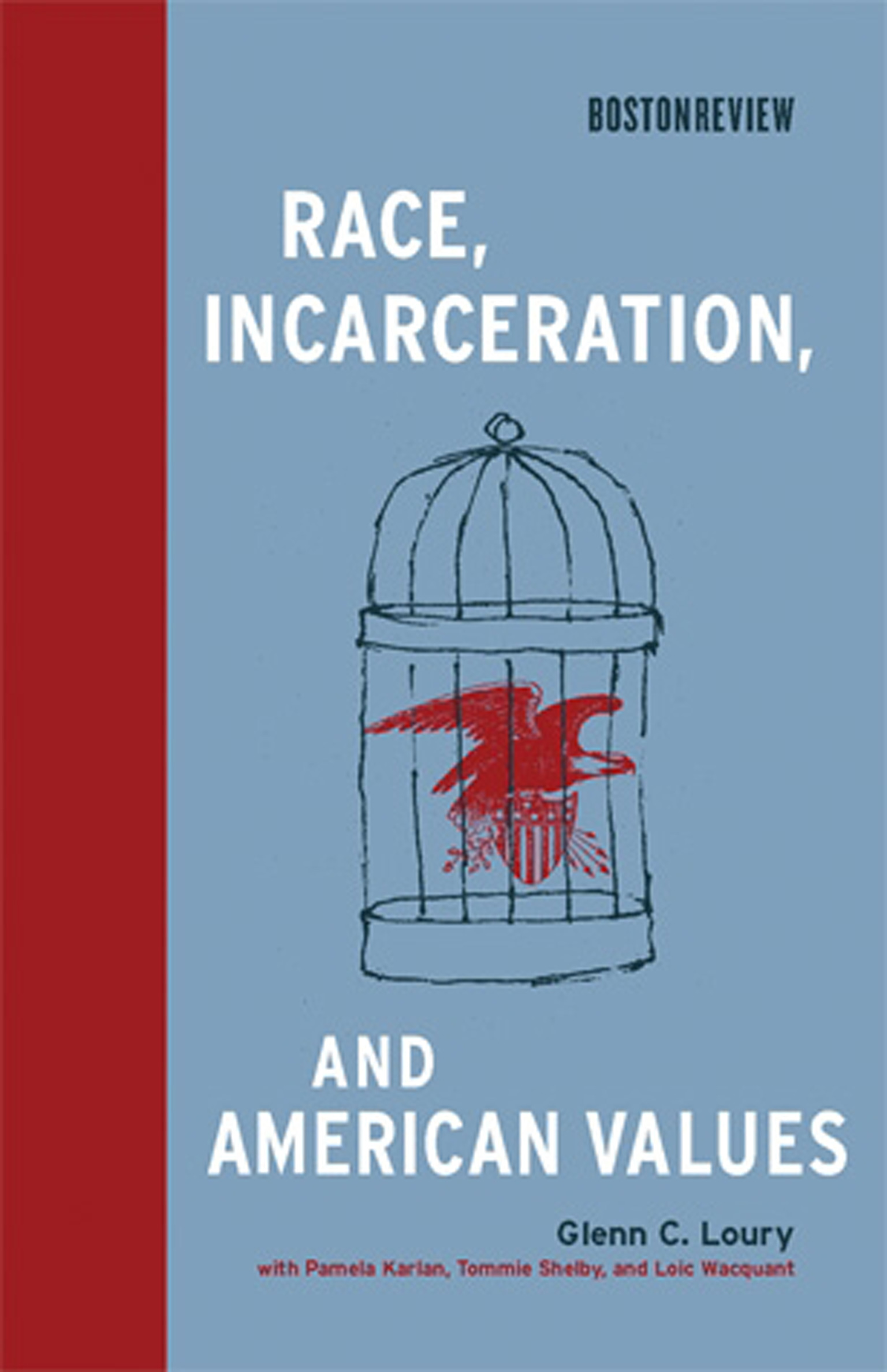
Race, Incarceration, and American Values Why stigmatizing and confining a large segment of our population should be unacceptable to all Americans. The United States, home to five percent of the world's population, now houses twenty-five percent of the world's prison inmates. Our incarceration rate—at 714 per 100,000 residents and rising—is almost forty percent greater than our nearest competitors (the Bahamas, Belarus, and Russia). More pointedly, it is 6.2 times the Canadian rate and 12.3 times the rate in Japan. Economist Glenn Loury argues that this extraordinary mass incarceration is not a response to rising crime rates or a proud success of social policy. Instead, it is the product of a generation-old collective decision to become a more punitive society. He connects this policy to our history of racial oppression, showing that the punitive turn in American politics and culture emerged in the post-civil rights years and has today become the main vehicle for the reproduction of racial hierarchies. Whatever the explanation, Loury argues, the uncontroversial fact is that changes in our criminal justice system since the 1970s have created a nether class of Americans—vastly disproportionately black and brown—with severely restricted rights and life chances. Moreover, conservatives and liberals agree that the growth in our prison population has long passed the point of diminishing returns. Stigmatizing and confining of a large segment of our population should be unacceptable to Americans. Loury's call to action makes all of us now responsible for ensuring that the policy changes. POLITICAL SCIENCE,Human Rights
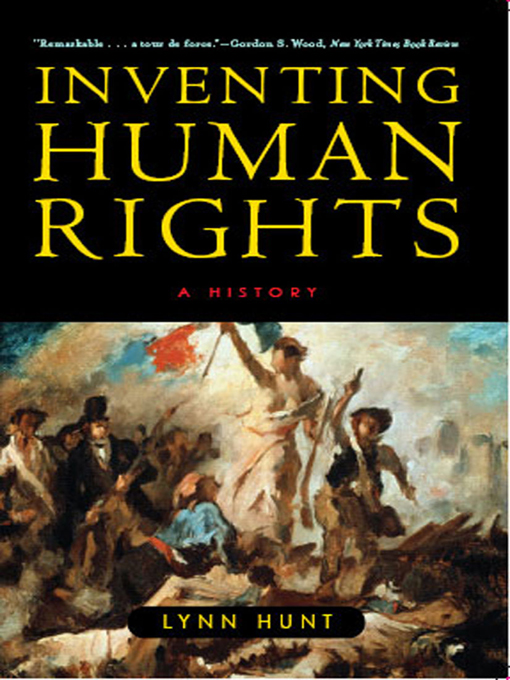
Inventing Human Rights “A tour de force.â€â€”Gordon S. Wood, New York Times Book Review How were human rights invented, and how does their tumultuous history influence their perception and our ability to protect them today? From Professor Lynn Hunt comes this extraordinary cultural and intellectual history, which traces the roots of human rights to the rejection of torture as a means for finding the truth. She demonstrates how ideas of human relationships portrayed in novels and art helped spread these new ideals and how human rights continue to be contested today. POLITICAL SCIENCE,Human Rights
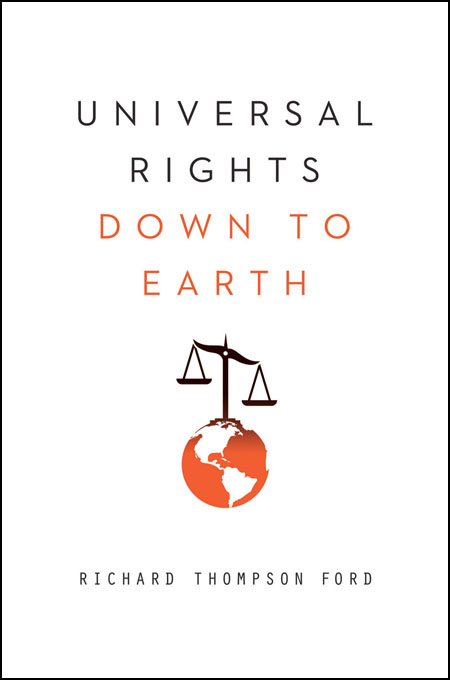
Universal Rights Down to Earth (Norton Global Ethics Series) A path-blazing lesson on how to reconcile lofty human rights ambitions with political and cultural realities. The idea of universal rights—rights shared by all citizens, regardless of nationality, creed, wealth, or geography—has a powerful grip on the way many people feel about justice and global politics. No one should be subjected to torture or disappearance, to starvation or sex trafficking, to economic exploitation or biased treatment under the law. But when it comes to actually enforcing these rights, the results rarely resemble the ideal. In Universal Rights Down to Earth, acclaimed author and legal expert Richard Thompson Ford reveals how attempts to apply “universal†human rights principles to specific cultures can hinder humanitarian causes and sometimes even worsen conditions for citizens. In certain regions, human rights ideals clash with the limits of institutional capabilities or civic culture; elsewhere, rights enforcement leads to further human rights violations. And in some countries, offending regimes use human rights commitments to distract attention from or justify their other abuses. Ford explores how our haste to identify every ideal as a universal right devalues rights as a whole, so that even the most important protections—such as that against torture—become negotiable. In clear, persuasive prose, Ford explores cases ranging from food distribution to the poor in India to sex work in Japan, illustrating how a rights-based approach to these problems often impedes more effective measures—the pragmatic politics of cost weighing, compromise, and collective action. The bad news is that improving lives worldwide isn’t as easy as making a declaration. But the good news, as Universal Rights Down to Earth powerfully demonstrates, is that if we are clear-eyed and culturally aware, it can be done. POLITICAL SCIENCE,Human Rights
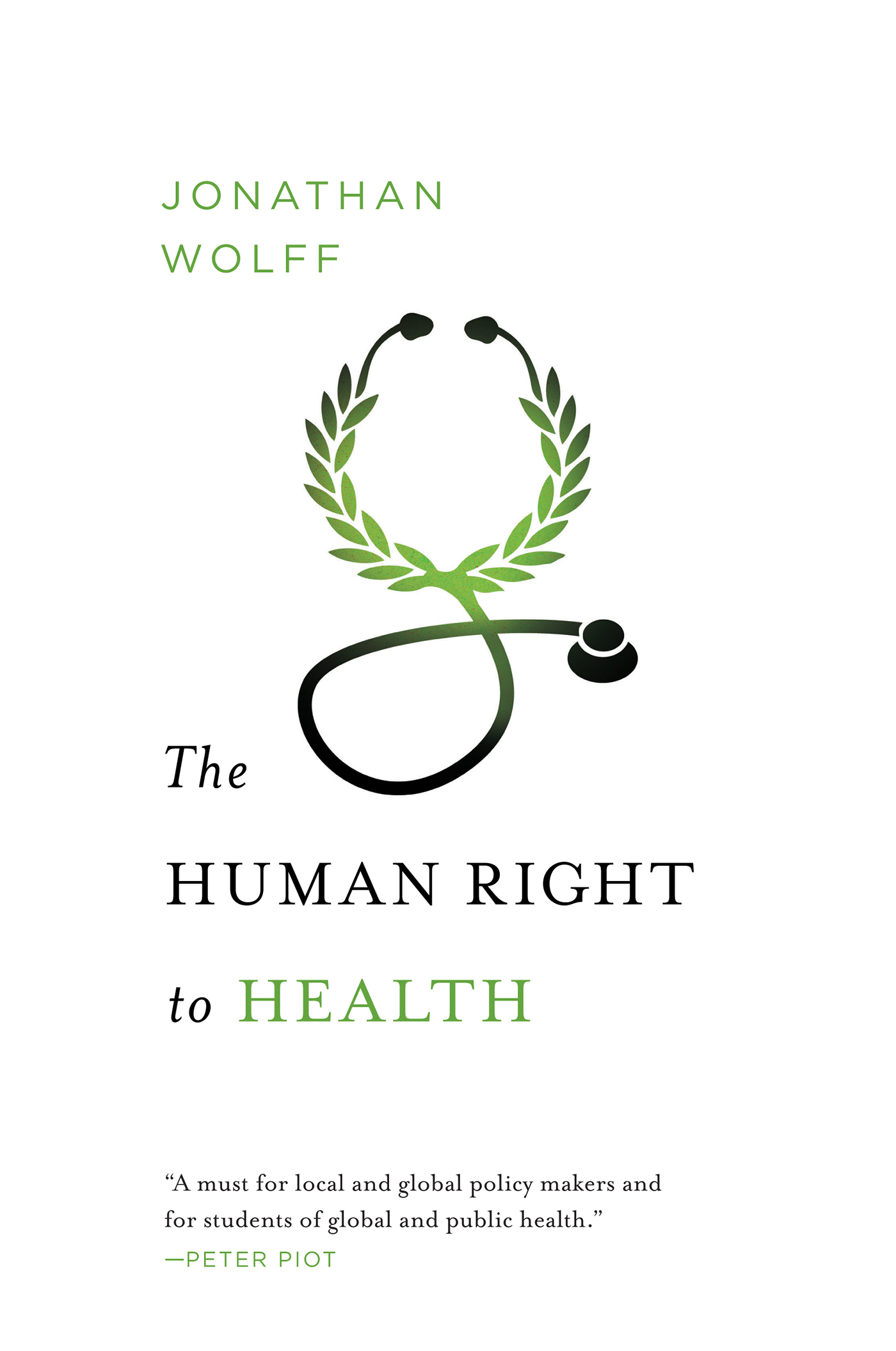
The Human Right to Health (Norton Global Ethics Series) “A broad-ranging, insightful analysis of the complex practical and ethical issues involved in global health.â€â€”Kirkus Reviews Few topics in human rights have inspired as much debate as the right to health. Proponents would enshrine it as a fundamental right on a par with freedom of speech and freedom from torture. Detractors suggest that the movement constitutes an impractical over-reach. Jonathan Wolff cuts through the ideological stalemate to explore both views. In an accessible, persuasive voice, he explores the philosophical underpinnings of the idea of a human right, assesses whether health meets those criteria, and identifies the political and cultural realities we face in attempts to improve the health of citizens in wildly different regions. Wolff ultimately finds that there is a path forward for proponents of the right to health, but to succeed they must embrace certain intellectual and practical changes. The Human Right to Health is a powerful and important contribution to the discourse on global health. POLITICAL SCIENCE,Human Rights
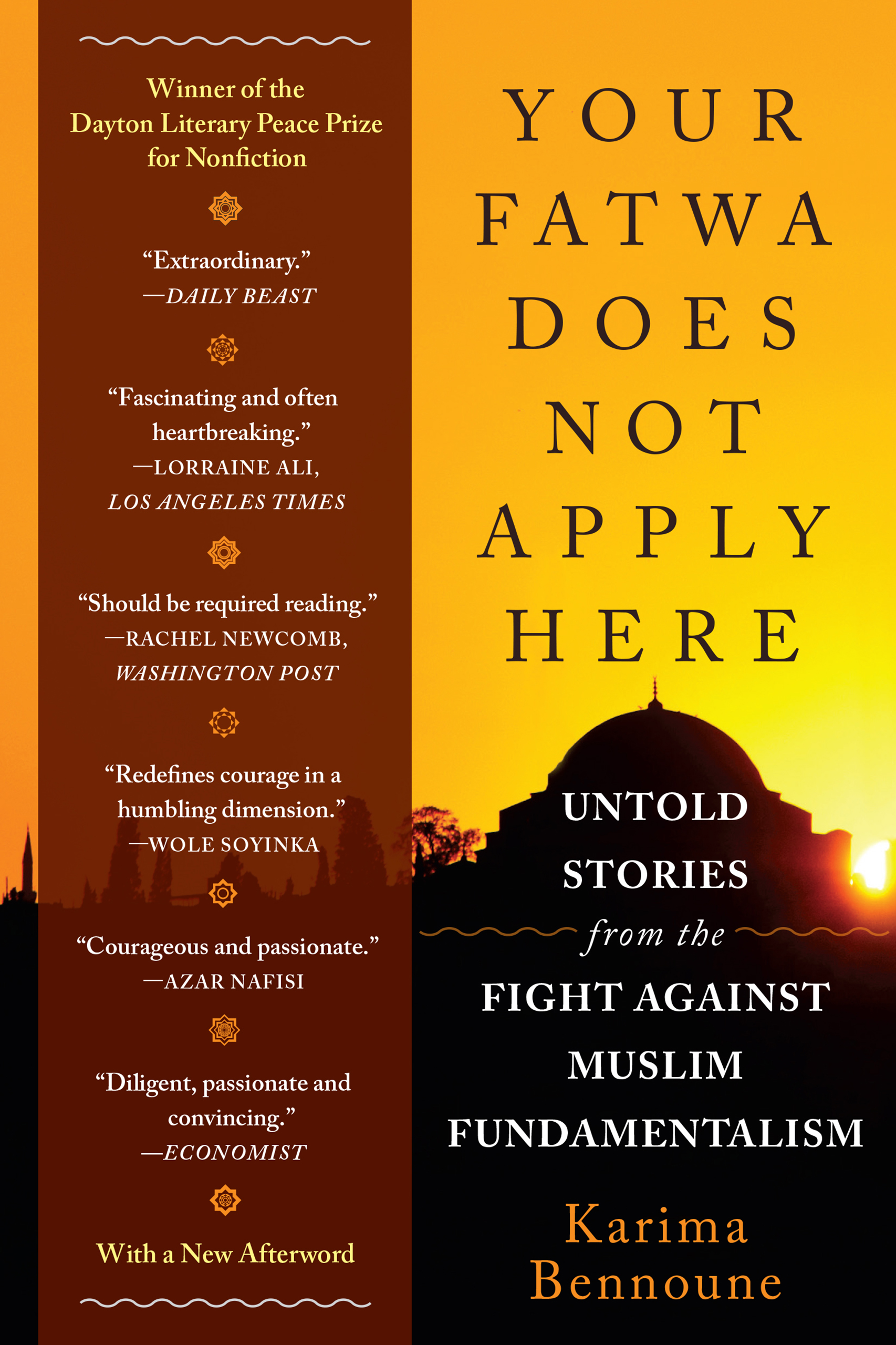
Your Fatwa Does Not Apply Here "Compelling, meticulously researched…[S]hould be required reading." —Washington Post In Pakistan, Faizan Peerzada staged a performing arts festival despite bomb attacks. In Algeria, radio comedian Mohamed Ali Allalou lampooned fundamentalists on the airwaves. Karima Bennoune illuminates these and other inspiring stories of the Muslim writers, artists, doctors, lawyers, activists, and educators who often risk death to combat the rising tide of religious extremism within their own countries. From Karachi to Tunis, Kabul to Tehran, these heroic trailblazers represent one of the best hopes for ending fundamentalist oppression worldwide. POLITICAL SCIENCE,Human Rights
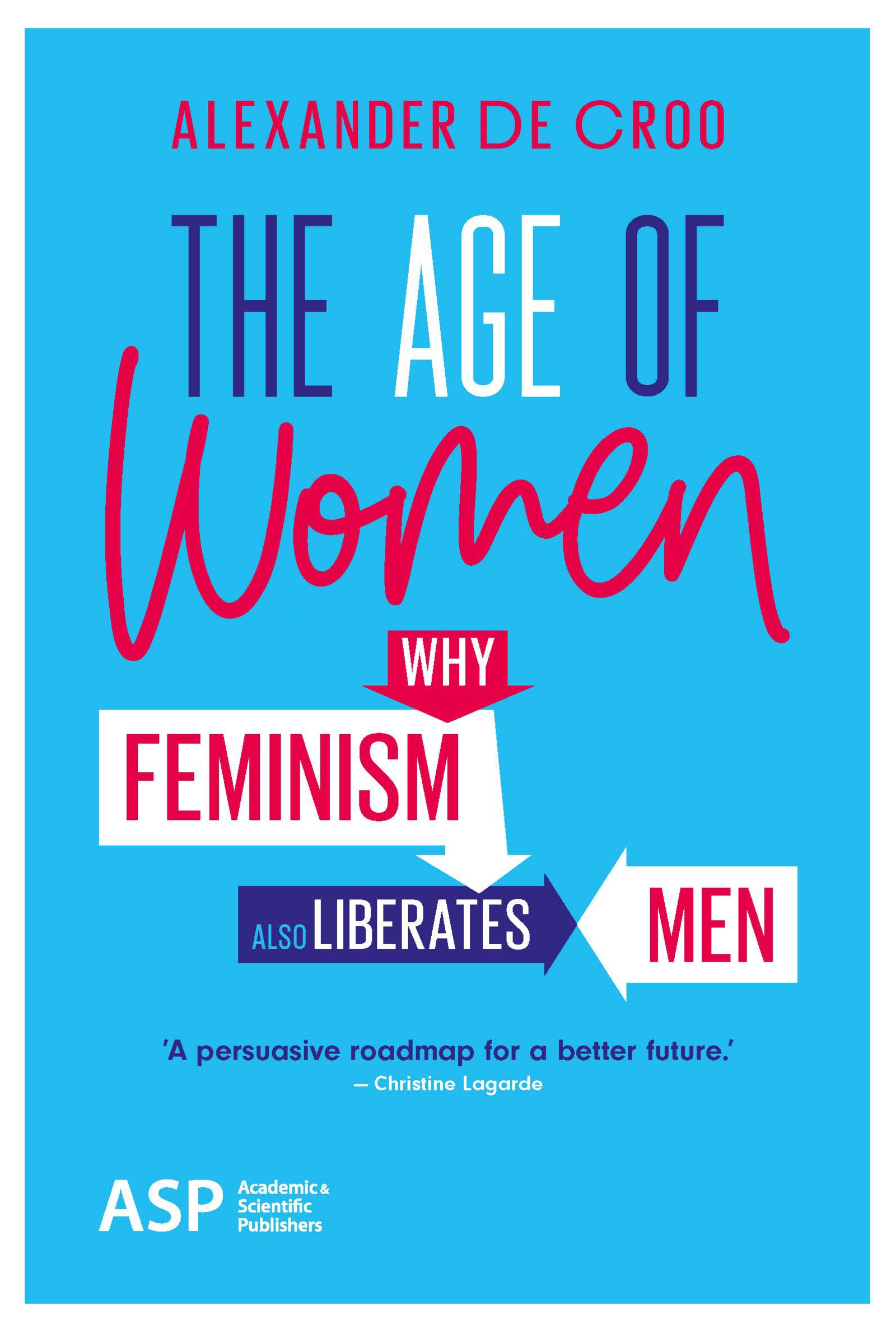
The Age of Women The future is now—and it is female. Women and women's rights are the key to progress. We believe in the West that we have already solved gender issues; it is the rest of the world that still has a problem. Nothing could be further from the truth! We have to do better. Through his work as Deputy Prime Minister and Belgian Minister of International Development, Alexander De Croo has discovered that the role of women worldwide is filled with too little opportunity and too much bias. In this book, he makes an impassioned plea for gender equality with data and stories to demonstrate the far-reaching benefits. POLITICAL SCIENCE,Human Rights

Upholding Justice This book critically examines the social, psychological and legal perspectives of justice. It brings together a wide range of contemporary and relevant issues relating to the gross violation of human rights and presents situation-based evidence from firsthand experiences of behavioral, social as well as legal professionals. It deals with themes such as civic and legal rights of children; dignity of the third gender in India; food justice in a welfare state; rights of disabled children; secret marriage of individuals with mental health challenges; and ethics and good governance. Topical and comprehensive, this book will be an excellent read for scholars and researchers of political studies, legal studies, human rights, psychology, behavioral studies, political sociology, sociology, development studies, governance and public policy, and South Asian studies. It will also interest policy makers, NGOs, activists and professionals in the field. POLITICAL SCIENCE,Human Rights

Imperialism Vladimir Lenin created this hugely significant Marxist text to explain fully the inevitable flaws and destructive power of Capitalism: that it would lead unavoidably to imperialism, monopolies and colonialism. He prophesied that those third world countries used merely as capitalist labour would have no choice but to join the Communist revolution in Russia. GREAT IDEAS. Throughout history, some books have changed the world. They have transformed the way we see ourselves - and each other. They have inspired debate, dissent, war and revolution. They have enlightened, outraged, provoked and comforted. They have enriched lives - and destroyed them. Now Penguin brings you the works of the great thinkers, pioneers, radicals and visionaries whose ideas shook civilization and helped make us who we are. POLITICAL SCIENCE,Imperialism

Culture and Imperialism A landmark work from the author of Orientalism that explores the long-overlooked connections between the Western imperial endeavor and the culture that both reflected and reinforced it. In the nineteenth and early twentieth centuries, as the Western powers built empires that stretched from Australia to the West Indies, Western artists created masterpieces ranging from Mansfield Park to Heart of Darkness and Aida. Yet most cultural critics continue to see these phenomena as separate. Edward Said looks at these works alongside those of such writers as W. B. Yeats, Chinua Achebe, and Salman Rushdie to show how subject peoples produced their own vigorous cultures of opposition and resistance. Vast in scope and stunning in its erudition, Culture and Imperialism reopens the dialogue between literature and the life of its time. POLITICAL SCIENCE,Imperialism
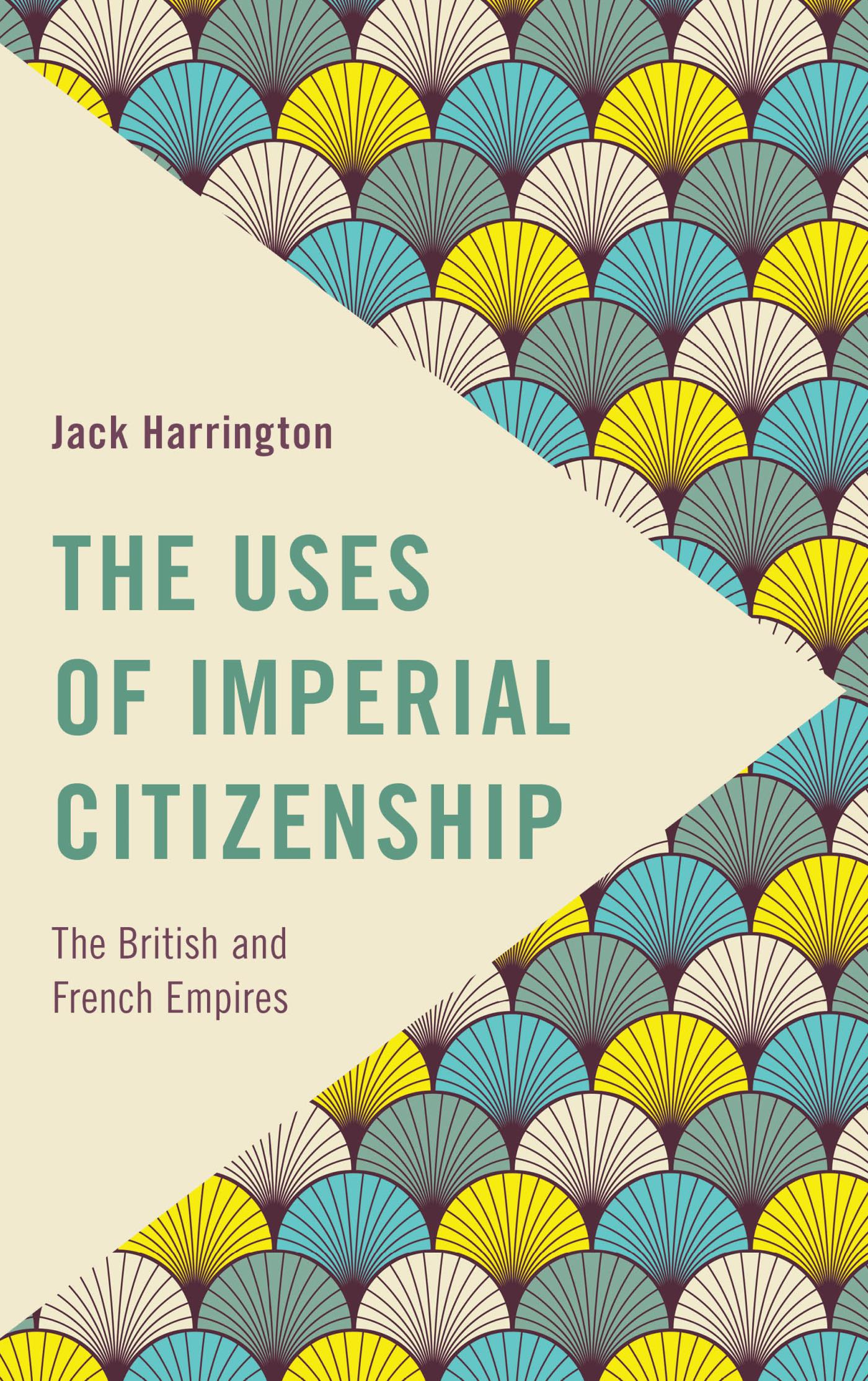
The Uses of Imperial Citizenship This book examines how ideas of citizenship and subjecthood were applied in societies under British and French imperial rule in order to expand our understanding of these concepts. POLITICAL SCIENCE,Imperialism

The Master of Disguise From the author of Argo comes an unforgettable behind-the-scenes story of espionage in action. In the first ever memoir by a top-level operative to be authorized by the CIA, Antonio J. Mendez reveals the cunning tricks and insights that helped save hundreds from deadly situations. Adept at creating new identities for anyone, anywhere, Mendez was involved in operations all over the world, from "Wild West" adventures in East Asia to Cold War intrigue in Moscow. In 1980, he orchestrated the escape of six Americans from a hostage situation in revolutionary Tehran, Iran. This extraordinary operation inspired the movie Argo, directed by and starring Ben Affleck. The Master of Disguise gives us a privileged look at what really happens at the highest levels of international espionage: in the field, undercover, and behind closed doors. POLITICAL SCIENCE,Intelligence & Espionage

In the President's Secret Service After conducting exclusive interviews with more than one hundred current and former Secret Service agents, bestselling author and award-winning reporter Ronald Kessler reveals their secrets for the first time. Never before has a journalist penetrated the wall of secrecy that surrounds the U.S. Secret Service, that elite corps of agents who pledge to take a bullet to protect the president and his family. Kessler portrays the dangers that agents face and how they carry out their missions--from how they are trained to how they spot and assess potential threats. With fly-on-the-wall perspective, he captures the drama and tension that characterize agents’ lives and reveals what they have seen, providing startling, previously untold stories about the presidents, from John F. Kennedy and Lyndon Johnson to George W. Bush and Barack Obama, as well as about their families, Cabinet officers, and White House aides. POLITICAL SCIENCE,Intelligence & Espionage

Spying Blind In this pathbreaking book, Amy Zegart provides the first scholarly examination of the intelligence failures that preceded September 11. Until now, those failures have been attributed largely to individual mistakes. But Zegart shows how and why the intelligence system itself left us vulnerable. Zegart argues that after the Cold War ended, the CIA and FBI failed to adapt to the rise of terrorism. She makes the case by conducting painstaking analysis of more than three hundred intelligence reform recommendations and tracing the history of CIA and FBI counterterrorism efforts from 1991 to 2001, drawing extensively from declassified government documents and interviews with more than seventy high-ranking government officials. She finds that political leaders were well aware of the emerging terrorist danger and the urgent need for intelligence reform, but failed to achieve the changes they sought. The same forces that have stymied intelligence reform for decades are to blame: resistance inside U.S. intelligence agencies, the rational interests of politicians and career bureaucrats, and core aspects of our democracy such as the fragmented structure of the federal government. Ultimately failures of adaptation led to failures of performance. Zegart reveals how longstanding organizational weaknesses left unaddressed during the 1990s prevented the CIA and FBI from capitalizing on twenty-three opportunities to disrupt the September 11 plot. Spying Blind is a sobering account of why two of America's most important intelligence agencies failed to adjust to new threats after the Cold War, and why they are unlikely to adapt in the future. POLITICAL SCIENCE,Intelligence & Espionage
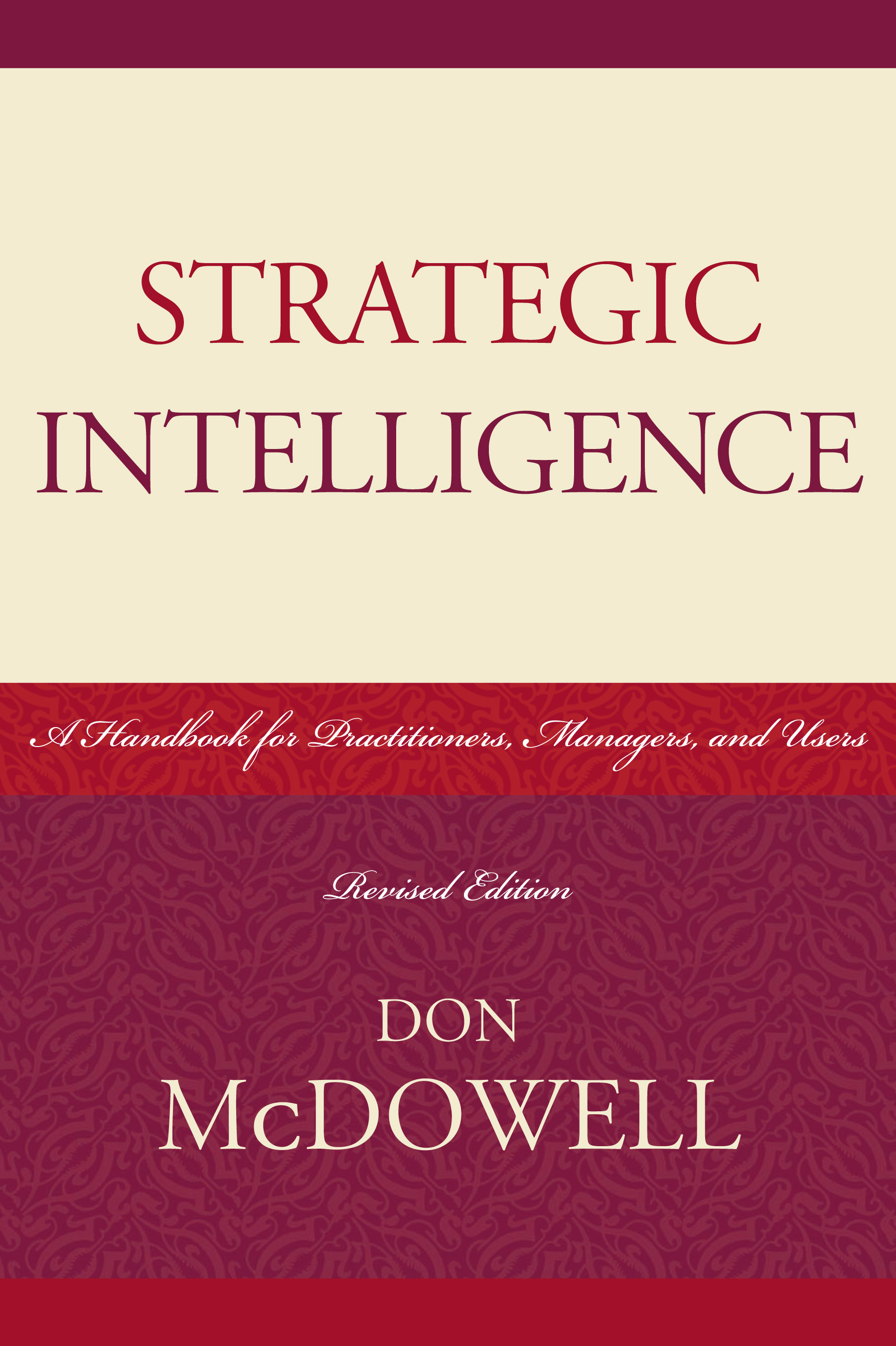
Strategic Intelligence The revised edition of Strategic Intelligence: A Handbook for Practitioners, Managers, and Users is a primer for analysts involved in conducting strategic intelligence research. Author Don McDowell begins with an overview of what strategic intelligence and analysis is, the functions it performs, and outcomes it delivers. McDowell then outlines a proven methodological approach to planning and implementing a strategic research project useful in any setting whatsoever. POLITICAL SCIENCE,Intelligence & Espionage
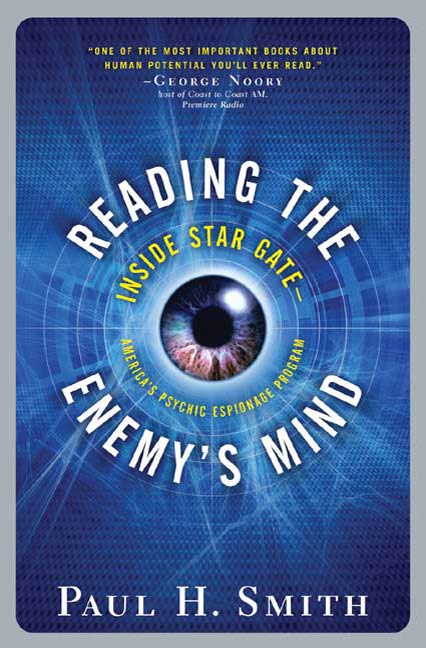
Reading the Enemy's Mind If you thought The Manchurian Candidate was fiction or John Farris's The Fury, which featured a CIA mind-control program run amok, was the stuff of an overheated imagination, you were sorely mistaken. From behind the cloak of U.S. military secrecy comes the story of Star Gate, the project that for nearly a quarter of a century trained soldiers and civilian spies in extra-sensory perception (ESP). Their objective: To search out the secrets of America's cold war enemies using a skill called "remote viewing." Paul H. Smith, a U.S. Army Major, was one of these viewers. Assigned to the remote viewing unit in 1983 at a pivotal time in its history, Smith served for the rest of the decade, witnessing and taking part in many of the seminal national-security crises of the twentieth century. With the Star Gate secrets declassified and the program mothballed by the Central Intelligence Agency, the story can now be told of the ordinary soldiers drafted onto the battlefield of human consciousness. Using hundreds of interviews with the key players in the Star Gate program, and gathering thousands of pages of documents, Smith opens the records on this remarkable chapter in American military, scientific, and cultural history. He reveals many secrets about how remote viewing works and how it was used against enemy targets. Among these stories are the search for hostages in Lebanon; spying on Soviet directed energy weapons; investigating the bombing of Pan Am Flight 103 over Lockerbie, Scotland; tracking foreign testing of weapons of mass destruction; combating narco-trafficking off America's coasts; aiding in the Iranian hostage situation; finding KGB moles in the CIA; pursuing Middle East terrorists; and more. Between the lines in the official records are revelations about unrelenting attempts from within and without to destroy the remote viewing program, and the efforts that kept Star Gate going for more than two decades in spite of its enemies. This is a story for the believer and the skeptic---a rare look at the innards of a top secret program and an eye-opening treatise on the power of the human mind to transcend the limitations of space and time. At the Publisher's request, this title is being sold without Digital Rights Management Software (DRM) applied. POLITICAL SCIENCE,Intelligence & Espionage

The Spy Who Stayed Out in the Cold Robert Philip Hansen thought he was smarter than the system. For decades, the quirky but respected counterintelligence expert, religious family man, and father of six, sold top secret information to agents of the Soviet Union and Russia. A self-taught computer expert, Hansen often encrypted his stolen files on wafer-thin disks. The data-some 6000 pages of highly classified documents-revealed precious nuclear secrets, outlined American espionage initiatives, and named names of agents-spies who covertly worked for both sides. Soviet government leaders, and their successors in the Russian Federation, used the stolen information to undermine U.S. policies and to eliminate spies in their own ranks. Moscow did not allow their moles the luxury of a defense: at least two men named by Hanssen were executed; a third languished for years in a Siberian hard labor camp. For more than twenty years, Bob Hanssen was the perfect spy. He personally collected at least $600,000 from his Russian handlers while another $800,000 was deposited in his name at a Moscow bank. Along with the cash came Rolex watches and cut diamonds. The money financed both his children's education at schools run by the elite and ultra-conservative Catholic organization, Opus Dei, and an inexplicably strange fling with a former Ohio "stripper of the year." But he didn't just do it for the money; he did it for the thrill and for a mysterious third reason rooted in religious mysticism. He lacked the people skills to play office politics, and it seemed the aging FBI analyst faced a disappointing career mired in middle management. Instead, he chose to become one of the most dangerous spies in America's history. And no one suspected him until just weeks before his arrest. Robert Philip Hanssen thought he was smarter than the system. And until February 18, 2001, he was right. That's when federal agents surrounded him while he was attempting to complete an exchange with his handlers at a Virginia park. When the G-men captured their mark, they catapulted the once innocuous bureaucrat onto the front pages of every newspaper in America. The most notorious spy since the Rosenbergs had finally become a victim of his own undoing. Now, drawing on more than 100 interviews with Bob Hanssen's friends, colleagues, coworkers, and family members, and confidential sources, best-selling author Adrian Havill tells the entire story you haven't read as only he can. The Spy Who Stayed Out in the Cold tells not only how he did it, but why. POLITICAL SCIENCE,Intelligence & Espionage
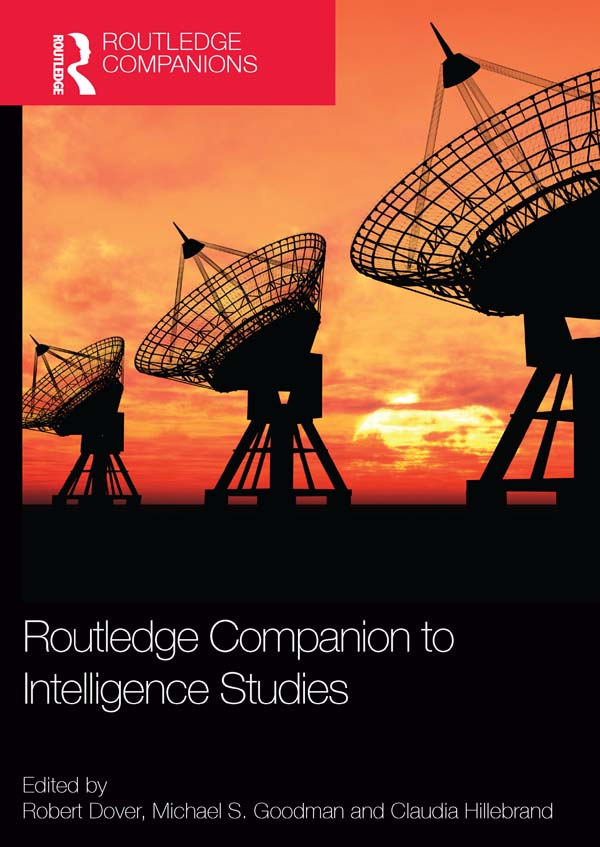
Routledge Companion to Intelligence Studies The Routledge Companion to Intelligence Studies provides a broad overview of the growing field of intelligence studies. The recent growth of interest in intelligence and security studies has led to an increased demand for popular depictions of intelligence and reference works to explain the architecture and underpinnings of intelligence activity. Divided into five comprehensive sections, this Companion provides a strong survey of the cutting-edge research in the field of intelligence studies: Part I: The evolution of intelligence studies; Part II: Abstract approaches to intelligence; Part III: Historical approaches to intelligence; Part IV: Systems of intelligence; Part V: Contemporary challenges. With a broad focus on the origins, practices and nature of intelligence, the book not only addresses classical issues, but also examines topics of recent interest in security studies. The overarching aim is to reveal the rich tapestry of intelligence studies in both a sophisticated and accessible way. This Companion will be essential reading for students of intelligence studies and strategic studies, and highly recommended for students of defence studies, foreign policy, Cold War studies, diplomacy and international relations in general. POLITICAL SCIENCE,Intelligence & Espionage
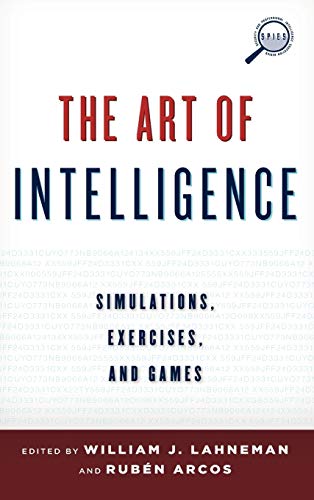
The Art of Intelligence This is the first textbook to offer in one volume original simulations, exercises, and games designed by academics and intelligence professionals from several countries. These innovative methods are meant to enhance the learning experience and provide an international perspective to the topics and approaches discussed in class. Intelligence simulations and games are presented in ready-to-run formats, from easy instructions to result-recordings matrices, to minimize preparation time for both instructors and students. Exercises, such as cyber-attack simulations, information sharing, ethical scenarios, and more, expose the student to the many subtle aspects of the intelligence enterprise through active role-playing in simulations and game exercises. The cases cover a wide range of key analytical issues and contexts with an international focus for an innovative text that will suit intelligence training courses at all levels. POLITICAL SCIENCE,Intelligence & Espionage
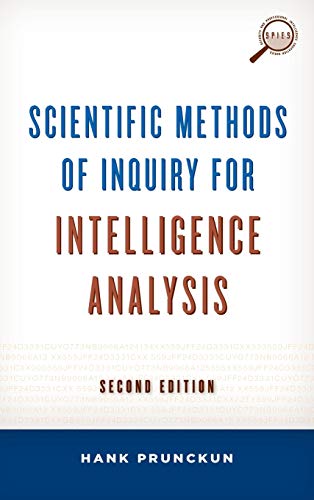
Scientific Methods of Inquiry for Intelligence Analysis Since 9/11, the needs of intelligence agencies as well as the missions they conduct have increased in number, size, and complexity. This expanded and updated edition offers a way of gaining the analytic skills essential to undertake intelligence work. It acquaints students and analysts with how intelligence fits into the larger research framework, covering not only the essentials of applied research, but also the function, structure, and operational methods specifically involved in intelligence work. It looks at how analysts work with classified information in a security conscious environment as well as obtain data via covert methods. POLITICAL SCIENCE,Intelligence & Espionage
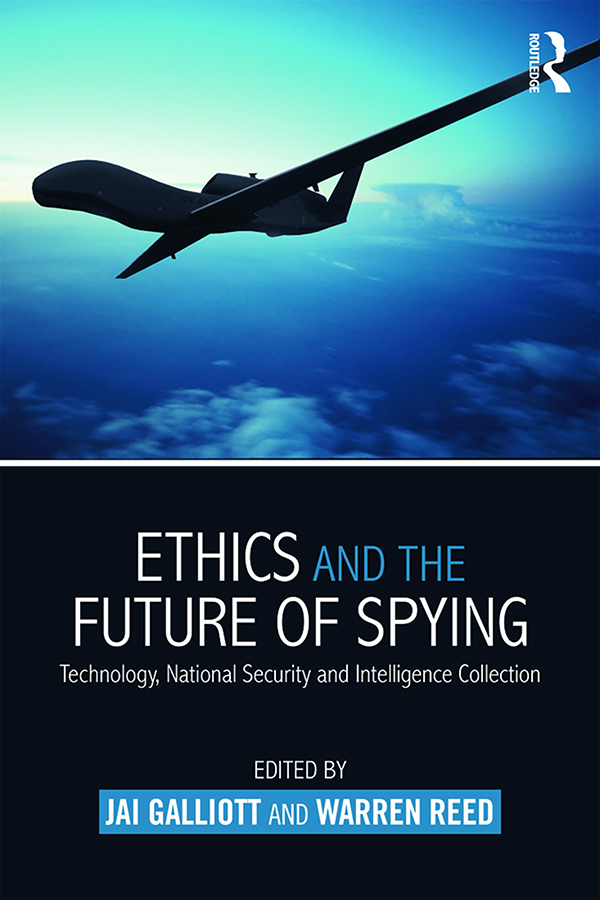
Ethics and the Future of Spying This volume examines the ethical issues generated by recent developments in intelligence collection and offers a comprehensive analysis of the key legal, moral and social questions thereby raised. Intelligence officers, whether gatherers, analysts or some combination thereof, are operating in a sea of social, political, scientific and technological change. This book examines the new challenges faced by the intelligence community as a result of these changes. It looks not only at how governments employ spies as a tool of state and how the ultimate outcomes are judged by their societies, but also at the mind-set of the spy. In so doing, this volume casts a rare light on an often ignored dimension of spying: the essential role of truth and how it is defined in an intelligence context. This book offers some insights into the workings of the intelligence community and aims to provide the first comprehensive and unifying analysis of the relevant moral, legal and social questions, with a view toward developing policy that may influence real-world decision making. The contributors analyse the ethics of spying across a broad canvas – historical, philosophical, moral and cultural – with chapters covering interrogation and torture, intelligence’s relation to war, remote killing, cyber surveillance, responsibility and governance. In the wake of the phenomena of WikiLeaks and the Edward Snowden revelations, the intelligence community has entered an unprecedented period of broad public scrutiny and scepticism, making this volume a timely contribution. This book will be of much interest to students of ethics, intelligence studies, security studies, foreign policy and IR in general. POLITICAL SCIENCE,Intelligence & Espionage

Sub Rosa A thrilling history of the Office of Strategic Services, America’s precursor to the CIA, and its secret operations behind enemy lines during World War II. Born in the fires of the Second World War, the Office of Strategic Services, or OSS, was the brainchild of legendary US Maj. Gen. William “Wild Bill†Donovan, designed to provide covert aid to resistance fighters in European nations occupied by Germany’s Nazi aggressors. Paratroopers Stewart Alsop and Thomas Braden—both of whom would become important political columnists in postwar years—became part of Wild Bill’s able collection of soldiers, spies, and covert operatives. Sub Rosa is an enthralling insider’s history of the remarkable intelligence operation that gave birth to the CIA. In Sub Rosa, Alsop and Braden take readers on a breathtaking journey through the birth and development of the top secret wartime espionage organization and detail many of the extraordinary OSS missions in France, Germany, Dakar and Casablanca in North Africa, and in the jungles of Burma that helped to hasten the end of the Japanese Empire and the fall of Adolf Hitler’s powerful Reich. As exciting as any international thriller written by Eric Ambler or Graham Greene, Alsop and Braden’s Sub Rosa is an indispensable addition to the literary history of American espionage and intelligence. POLITICAL SCIENCE,Intelligence & Espionage
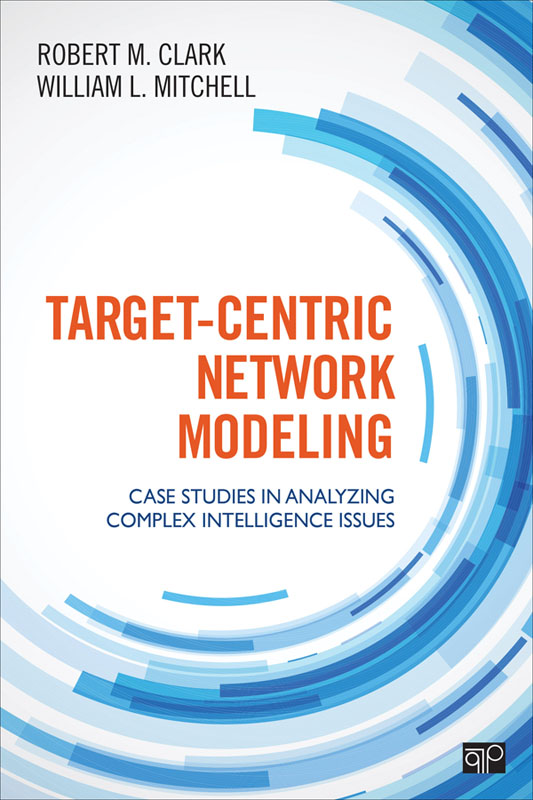
Target-Centric Network Modeling In Target-Centric Network Modeling: Case Studies in Analyzing Complex Intelligence Issues, authors Robert Clark and William Mitchell take an entirely new approach to teaching intelligence analysis. Unlike any other book on the market, it offers case study scenarios using actual intelligence reporting format, along with a tested process that facilitates the production of a wide range of analytical products for civilian, military, and hybrid intelligence environments. Readers will learn how to perform the specific actions of problem definition modeling, target network modeling, and collaborative sharing in the process of creating a high-quality, actionable intelligence product. The case studies reflect the complexity of twenty-first century intelligence issues. Working through these cases, students will learn to manage and evaluate realistic intelligence accounts. POLITICAL SCIENCE,Intelligence & Espionage

The CIA and the Congress for Cultural Freedom in the Early Cold War This book questions the conventional wisdom about one of the most controversial episodes in the Cold War, and tells the story of the CIA's backing of the Congress for Cultural Freedom. For nearly two decades during the early Cold War, the CIA secretly sponsored some of the world’s most feted writers, philosophers, and scientists as part of a campaign to prevent Communism from regaining a foothold in Western Europe and from spreading to Asia. By backing the Congress for Cultural Freedom, the CIA subsidized dozens of prominent magazines, global congresses, annual seminars, and artistic festivals. When this operation (QKOPERA) became public in 1967, it ignited one of the most damaging scandals in CIA history. Ever since then, many accounts have argued that the CIA manipulated a generation of intellectuals into lending their names to pro-American, anti-Communist ideas. Others have suggested a more nuanced picture of the relationship between the Congress and the CIA, with intellectuals sometimes resisting the CIA's bidding. Very few accounts, however, have examined the man who held the Congress together: Michael Josselson, the Congress’s indispensable manager—and, secretly, a long time CIA agent. This book fills that gap. Using a wealth of archival research and interviews with many of the figures associated with the Congress, this book sheds new light on how the Congress came into existence and functioned, both as a magnet for prominent intellectuals and as a CIA operation. This book will be of much interest to students of the CIA, Cold War History, intelligence studies, US foreign policy and International Relations in general. POLITICAL SCIENCE,Intelligence & Espionage

The Five Disciplines of Intelligence Collection Leading intelligence experts Mark M. Lowenthal and Robert M. Clark bring you an all new, groundbreaking title. The Five Disciplines of Intelligence Collection describes, in non-technical terms, the definition, history, process, management, and future trends of each intelligence collection source (INT). Authoritative and non-polemical, this book is the perfect teaching tool for classes addressing various types of collection. Chapter authors are past or current senior practitioners of the INT they discuss, providing expert assessment of ways particular types of collection fit within the larger context of the U.S. Intelligence Community. POLITICAL SCIENCE,Intelligence & Espionage
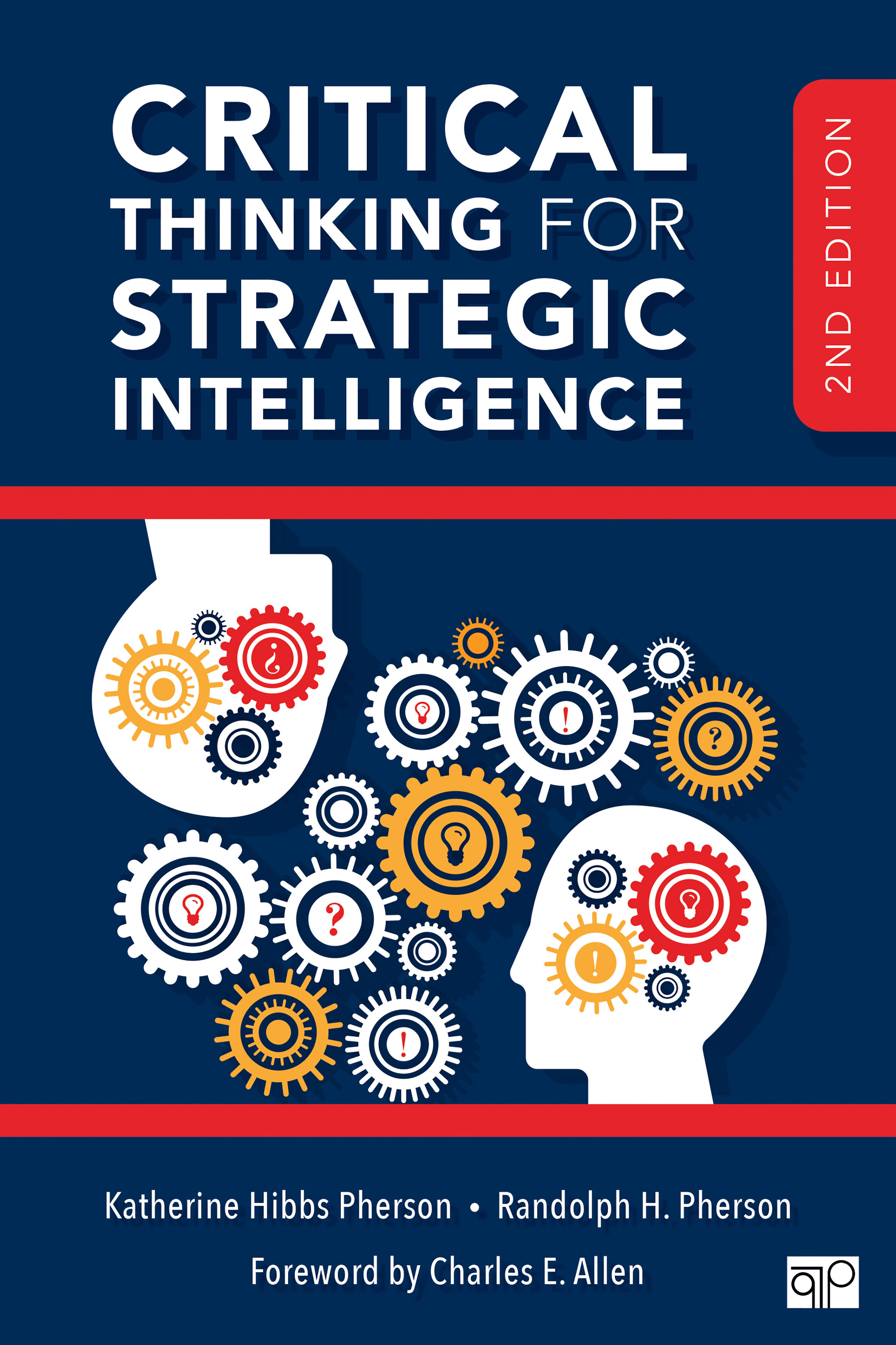
Critical Thinking for Strategic Intelligence With this second edition of Critical Thinking for Strategic Intelligence, Randolph H. Pherson and Katherine Hibbs Pherson update their highly regarded, easy-to-use handbook for developing core critical thinking skills and analytic techniques. This indispensable text is framed around 20 key questions that all analysts must ask themselves as they prepare to conduct research, generate hypotheses, evaluate sources of information, draft papers, and ultimately present analysis. New material includes a chapter on working with statistics and probabilities at an introductory level; discussions on how to work with social media; managing the “big data†phenomenon and what role analysis plays both at the front and back end of utilizing such information. Each of the book’s chapters are consistently organized, enabling students and analysts alike to easily trace the key steps of: Setting the Stage; Looking More Deeply; Key Takeaways; Considering the Case Study, and the book’s illustrations include useful graphics that diagram and display the processes and structured analytic techniques for arriving at the best possible analytical products. The “Analyst’s Roadmap†provides an at-a-glance “map†for readers depicting the best practices involved in perfecting the analytical product. A set of carefully crafted case studies on national intelligence, homeland security, and law enforcement issues illustrate how to apply these critical thinking skills tie directly to end-of-chapter questions, providing valuable self-assessment opportunities. POLITICAL SCIENCE,Intelligence & Espionage
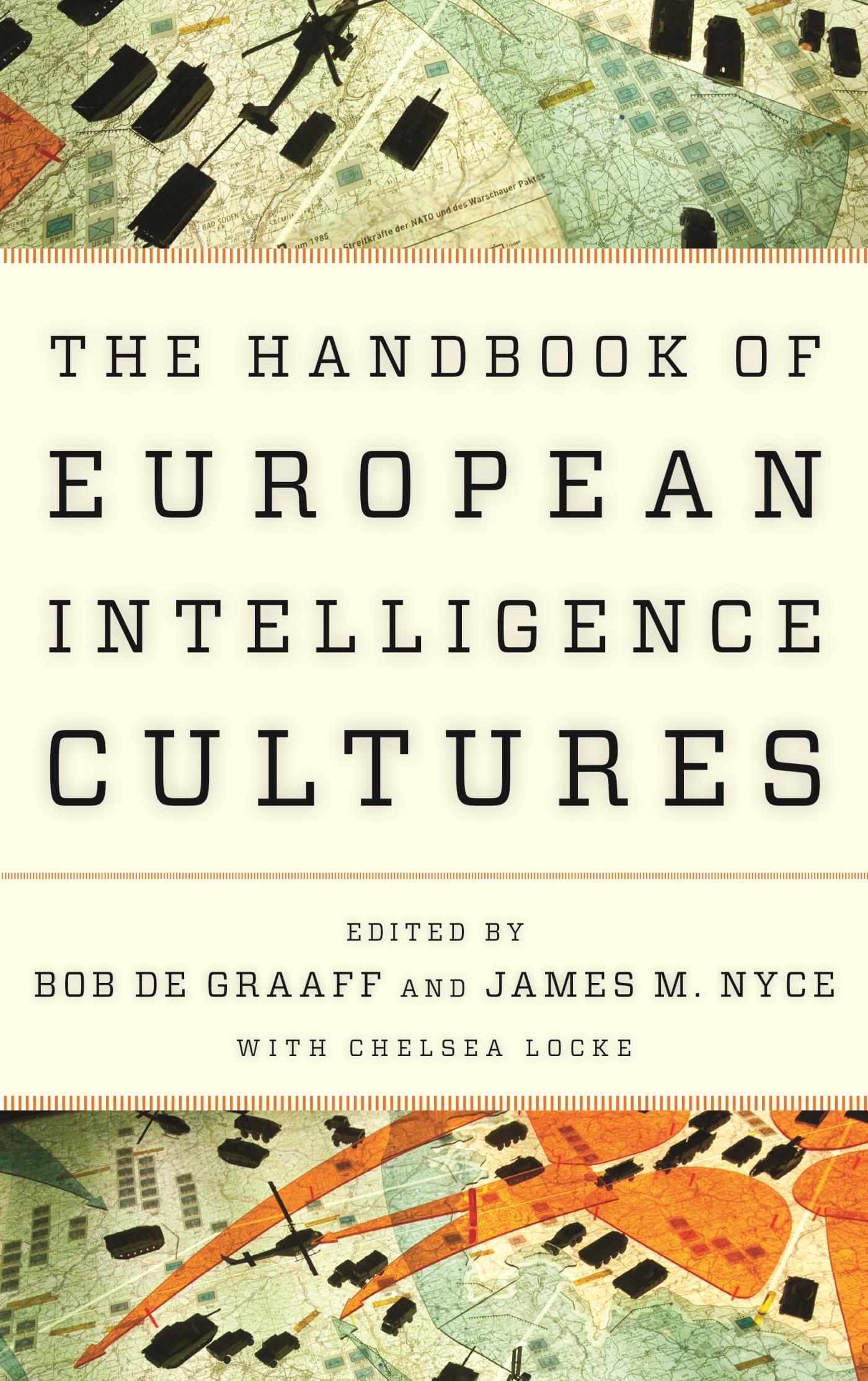
Handbook of European Intelligence Cultures As experts from the countries discussed, the contributors address the intelligence community rather than focusing on a single agency. Each entry looks at the environment in which an organization works, its actors, and cultural and ideological climate, to cover both the external and internal factors that influence a nation’s intelligence community. POLITICAL SCIENCE,Intelligence & Espionage

Drone Warrior “A must read for anyone who wants to understand the new American way of war.†— General Michael V. Hayden, former Director of the Central Intelligence Agency and the National Security Agency A former special operations member takes us inside America’s covert drone war in this headline-making, never-before-told account for fans of Zero Dark Thirty and Lone Survivor, told by a Pulitzer Prize-winning Wall Street Journal writer and filled with eye-opening and sure to be controversial details. For nearly a decade Brett Velicovich was at the center of America’s new warfare: using unmanned aerial vehicles—drones—to take down the world’s deadliest terrorists across the globe. One of an elite handful in the entire military with the authority to select targets and issue death orders, he worked in concert with the full human and technological network of American intelligence—assets, analysts, spies, informants—and the military’s elite operatives, to stalk, capture, and eliminate high value targets in al-Qaeda and ISIS. In this remarkable book, co-written with journalist Christopher S. Stewart, Velicovich offers unprecedented perspective on the remarkably complex nature of drone operations and the rigorous and wrenching decisions behind them. In intimate gripping detail, he shares insider, action-packed stories of the most coordinated, advanced, and secret missions that neutralized terrorists, preserved the lives of US and international warriors across the globe, and saved countless innocents in the hottest conflict zones today. Drone Warrior also chronicles the US military’s evolution in the past decade and the technology driving it. Velicovich considers the future it foretells, and speaks candidly on the physical and psychological toll it exacts, including the impact on his own life. He reminds us that while these machines can kill, they can also be used productively to improve and preserve life, including protecting endangered species, work he is engaged in today. Joining warfare classics such as American Sniper, Lone Survivor, and No Easy Day, Drone Warrior is the definitive account of our nation’s capacity and capability for war in the modern age. POLITICAL SCIENCE,Intelligence & Espionage

King of Spies The New York Times bestselling author of Escape from Camp 14 returns with the untold story of one of the most powerful spies in American history, shedding new light on the U.S. role in the Korean War, and its legacy In 1946, master sergeant Donald Nichols was repairing jeeps on the sleepy island of Guam when he caught the eye of recruiters from the army's Counter Intelligence Corps. After just three months' training, he was sent to Korea, then a backwater beneath the radar of MacArthur's Pacific Command. Though he lacked the pedigree of most U.S. spies—Nichols was a 7th grade dropout—he quickly metamorphosed from army mechanic to black ops phenomenon. He insinuated himself into the affections of America’s chosen puppet in South Korea, President Syngman Rhee, and became a pivotal player in the Korean War, warning months in advance about the North Korean invasion, breaking enemy codes, and identifying most of the targets destroyed by American bombs in North Korea. But Nichols's triumphs had a dark side. Immersed in a world of torture and beheadings, he became a spymaster with his own secret base, his own covert army, and his own rules. He recruited agents from refugee camps and prisons, sending many to their deaths on reckless missions. His closeness to Rhee meant that he witnessed—and did nothing to stop or even report—the slaughter of tens of thousands of South Korean civilians in anticommunist purges. Nichols’s clandestine reign lasted for an astounding eleven years. In this riveting book, Blaine Harden traces Nichols's unlikely rise and tragic ruin, from his birth in an operatically dysfunctional family in New Jersey to his sordid postwar decline, which began when the U.S. military sacked him in Korea, sent him to an air force psych ward in Florida, and subjected him—against his will—to months of electroshock therapy. But King of Spies is not just the story of one American spy. It is a groundbreaking work of narrative history that—at a time when North Korea is threatening the United States with long-range nuclear missiles—explains the origins of an intractable foreign policy mess. POLITICAL SCIENCE,Intelligence & Espionage

The Future of Intelligence Intelligence is, by definition, a shadowy business. Yet many aspects of this secret world are now more openly analyzed and discussed, a trend which has inevitably prompted lively debate about intelligence gathering and analysis: what should be allowed? What boundaries, if any, should be drawn? And what changes and challenges lie ahead for intelligence activities and agencies? In this compelling book, leading intelligence scholar Mark Lowenthal explores the future of intelligence. There are, he argues, three broad areas – information technology and intelligence collection; analysis; and governance – that indicate the potential for rather dramatic change in the world of intelligence. But whether these important vectors for change will improve how intelligence works or make it more difficult remains to be seen. The only certainty is that intelligence will remain an essential feature of statecraft in our increasingly dangerous world. Drawing on the author's forty years' experience in U.S. intelligence, The Future of Intelligence offers a broad and authoritative starting point for the ongoing debate about what intelligence could be and how it may function in the years ahead. POLITICAL SCIENCE,Intelligence & Espionage
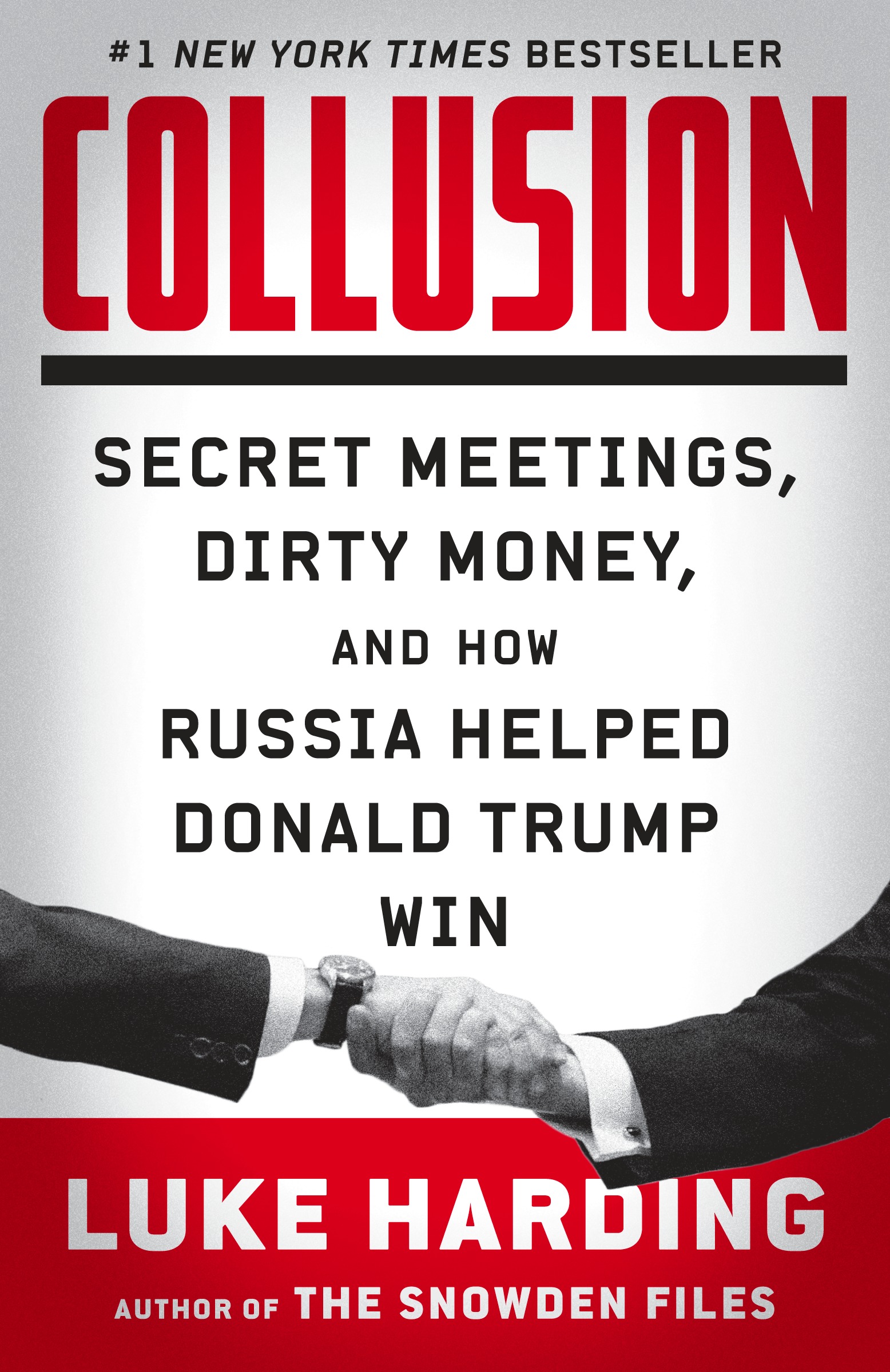
Collusion #1 NEW YORK TIMES BESTSELLER An explosive exposé that lays out the story behind the Steele Dossier, including Russia’s decades-in-the-making political game to upend American democracy and the Trump administration’s ties to Moscow. “Harding…presents a powerful case for Russian interference, and Trump campaign collusion, by collecting years of reporting on Trump’s connections to Russia and putting it all together in a coherent narrative.” —The Nation December 2016. Luke Harding, the Guardian reporter and former Moscow bureau chief, quietly meets former MI6 officer Christopher Steele in a London pub to discuss President-elect Donald Trump’s Russia connections. A month later, Steele’s now-famous dossier sparks what may be the biggest scandal of the modern era. The names of the Americans involved are well-known—Paul Manafort, Michael Flynn, Jared Kushner, George Papadopoulos, Carter Page—but here Harding also shines a light on powerful Russian figures like Aras Agalarov, Natalia Veselnitskaya, and Sergey Kislyak, whose motivations and instructions may have been coming from the highest echelons of the Kremlin. Drawing on new material and his expert understanding of Moscow and its players, Harding takes the reader through every bizarre and disquieting detail of the “Trump-Russia” story—an event so huge it involves international espionage, off-shore banks, sketchy real estate deals, the Miss Universe pageant, mobsters, money laundering, poisoned dissidents, computer hacking, and the most shocking election in American history. POLITICAL SCIENCE,Intelligence & Espionage

Introduction to Intelligence Studies Introduction to Intelligence Studies provides a comprehensive overview of intelligence and security issues confronting the United States today. Since the attacks of 9/11, the United States Intelligence Community has undergone an extensive overhaul. This textbook provides a comprehensive overview of intelligence and security issues, defining critical terms and reviewing the history of intelligence as practiced in the United States. Designed in a practical sequence, the book begins with the basics of intelligence, progresses through its history, describes best practices, and explores the way the intelligence community looks and operates today. The authors examine the ‘pillars’ of the American intelligence system—collection, analysis, counterintelligence, and covert operations—and demonstrate how these work together to provide ‘decision advantage’. The book offers equal treatment to the functions of the intelligence world—balancing coverage on intelligence collection, counterintelligence, information management, critical thinking, and decision-making. It also covers such vital issues as laws and ethics, writing and briefing for the intelligence community, and the emerging threats and challenges that intelligence professionals will face in the future. This revised and updated second edition addresses issues such as the growing influence of Russia and China, the emergence of the Islamic State, and the effects the Snowden and Manning leaks have had on the intelligence community. This book will be essential reading for students of intelligence studies, US national security, and IR in general. POLITICAL SCIENCE,Intelligence & Espionage

Beirut Rules From the New York Times bestselling coauthors of Under Fire--the riveting story of the kidnapping and murder of CIA Station Chief William Buckley. After a deadly terrorist bombing at the American embassy in Lebanon in 1983, only one man inside the CIA possessed the courage and skills to rebuild the networks destroyed in the blast: William Buckley. But the new Beirut station chief quickly became the target of a young terrorist named Imad Mughniyeh. Beirut Rules is the pulse-by-pulse account of Buckley's abduction, torture, and murder at the hands of Hezbollah terrorists. Drawing on never-before-seen government documents as well as interviews with Buckley's co-workers, friends and family, Burton and Katz reveal how the relentless search for Buckley in the wake of his kidnapping ignited a war against terror that continues to shape the Middle East to this day. POLITICAL SCIENCE,Intelligence & Espionage

The Assault on Intelligence A blistering critique of the forces threatening the American intelligence community, beginning with the President of the United States himself, in a time when that community's work has never been harder or more important In the face of a President who lobs accusations without facts, evidence, or logic, truth tellers are under attack. Meanwhile, the world order is teetering on the brink. North Korea is on the verge of having a nuclear weapon that could reach all of the United States, Russians have mastered a new form of information warfare that undercuts democracy, and the role of China in the global community remains unclear. There will always be value to experience and expertise, devotion to facts, humility in the face of complexity, and a respect for ideas, but in this moment they seem more important, and more endangered, than they've ever been. American Intelligence--the ultimate truth teller--has a responsibility in a post-truth world beyond merely warning of external dangers, and in The Assault on Intelligence, General Michael Hayden takes up that urgent work with profound passion, insight and authority. It is a sobering vision. The American intelligence community is more at risk than is commonly understood, for every good reason. Civil war or societal collapse is not necessarily imminent or inevitable, but our democracy's core structures, processes, and attitudes are under great stress. Many of the premises on which we have based our understanding of governance are now challenged, eroded, or simply gone. And we have a President in office who responds to overwhelming evidence from the intelligence community that the Russians are, by all acceptable standards of cyber conflict, in a state of outright war against us, not by leading a strong response, but by shooting the messenger. There are fundamental changes afoot in the world and in this country. The Assault on Intelligence shows us what they are, reveals how crippled we've become in our capacity to address them, and points toward a series of effective responses. Because when we lose our intelligence, literally and figuratively, democracy dies. POLITICAL SCIENCE,Intelligence & Espionage
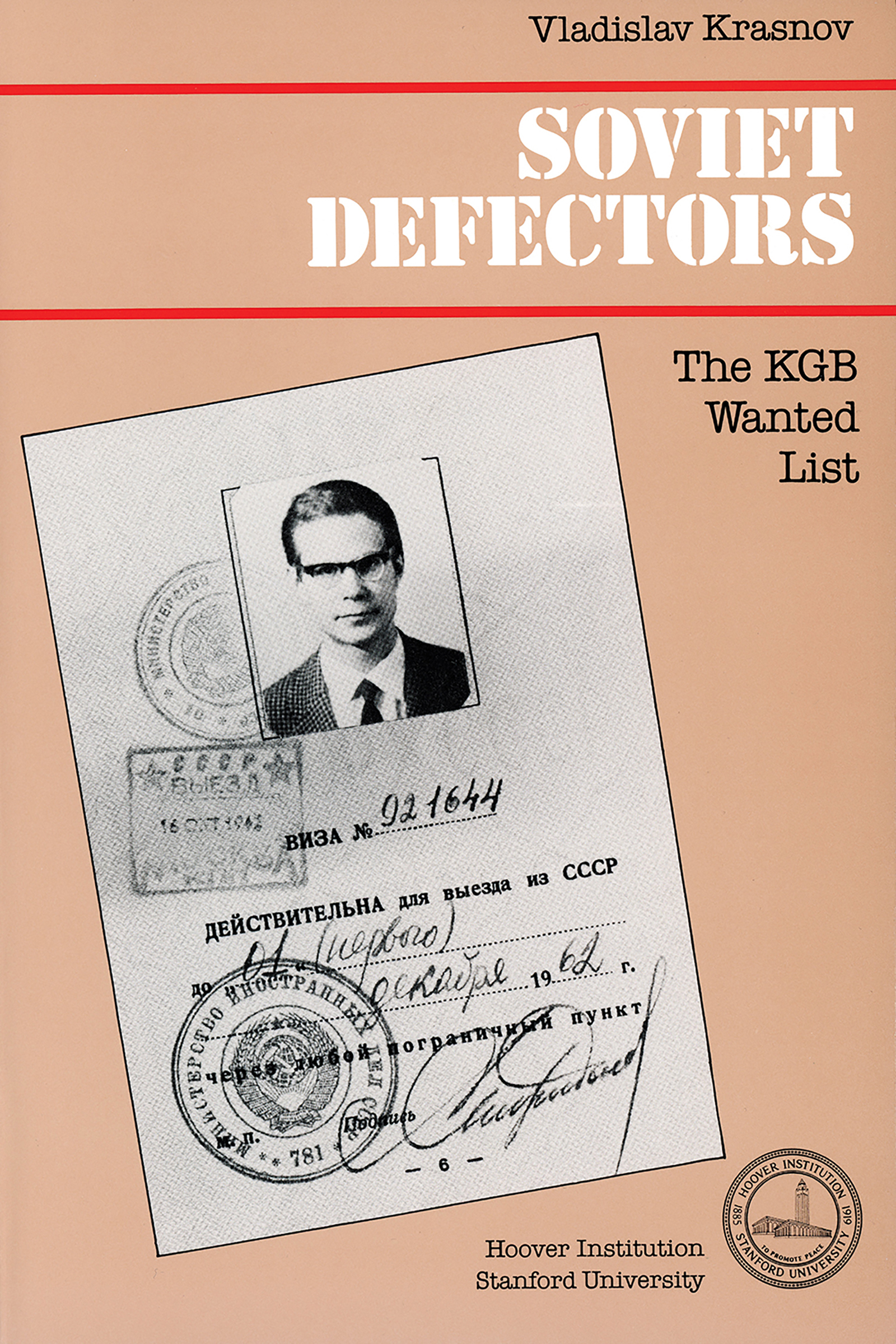
Soviet Defectors The topic of defection is taboo in the USSR, and the Soviets, are anxious to silence, downplay, or distort every case of defection. Surprisingly, Vladislav Krasnov reports, the free world has often played along with these Soviet efforts by treating defection primarily as a secretive matter best left to bureaucrats. As a result, defectors' human rights have sometimes been violated, and U.S. national security interests have been poorly served. POLITICAL SCIENCE,Intelligence & Espionage
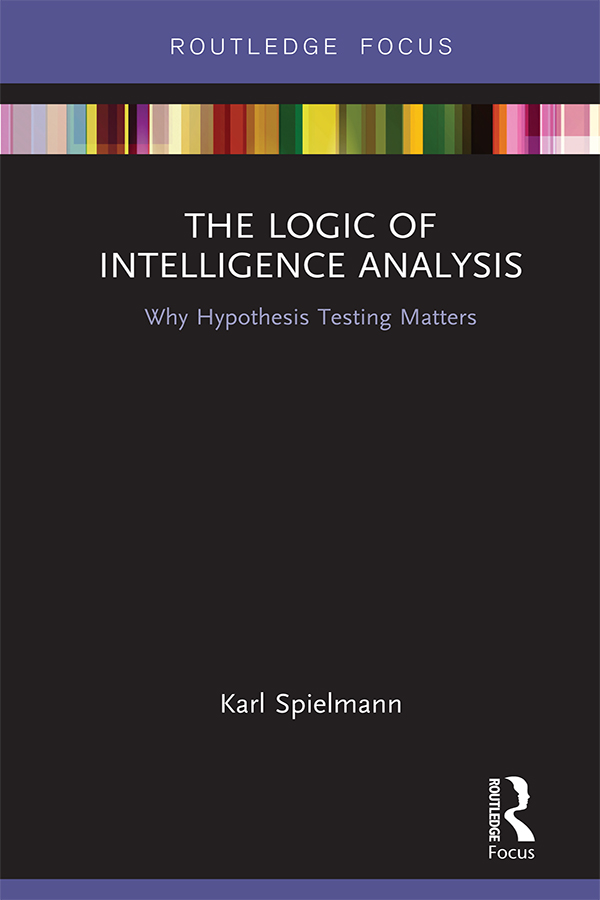
The Logic of Intelligence Analysis This book discusses the application of hypothesis testing to the practice of intelligence analysis. By drawing on longstanding procedures of scientific method, particularly hypothesis testing, this book strongly critiques standard intelligence analytic practices. It shows these practices to be inadequate, as they are illogical in terms of what formal philosophy says any intelligence analysts can realistically be expected to know, and for the future when analysts will face pressures to adapt to digital age modeling techniques. The methodology focuses on identifying and remedying analytic errors caused by analyst cognitive biases and by foreign denial and deception. To demonstrate that it is a practical tool, it walks analysts through a case study, step by step, to show how its hypothesis testing can be implemented. It also invites a comparative test in the real world with any other intelligence methodologies to assess its strengths and weaknesses in predicting the outcome of an actual "live" intelligence issue. This book will be of much interest to students of intelligence studies, public policy and national security, as well as practitioners. POLITICAL SCIENCE,Intelligence & Espionage

The Skripal Files The explosive story of the poisoning of the former Russian spy Sergei Skripal and what it reveals about the growing clandestine conflict between the West and Russia Salisbury, England: March 4, 2018. Slumped on a bench, paralyzed and barely able to breathe, were a former Russian intelligence officer named Sergei Skripal and his daughter, Yulia. Sergei had been living a quiet life in England since 2010, when he was expelled from Russia as part of a spy swap; he had been serving a lengthy prison sentence for working secretly for the British intelligence agency MI6. On this Sunday afternoon, he and his daughter had just finished lunch at a local restaurant when they started to feel faint. Within minutes they were close to death. The Skripals had been poisoned, not with a familiar toxin but with Novichok, a deadly nerve agent developed in southern Russia. Was this a message from the Kremlin that traitors would not escape violent death, even on British soil? As Sergei and Yulia fought for their lives, and the British government and their allies sought answers, relations between the West and Russia descended to a new low. The Skripal Files is a remarkable and definitive account of Sergei Skripal’s story, which lays bare the new spy war between Russia and the West. Mark Urban, the diplomatic and defense editor for the BBC, met with Skripal in the months before his poisoning, learning about his career in Russian military intelligence, how he became a British agent, his imprisonment in Russia, and the events that led to his release. Skripal’s first-hand accounts and experiences reveal the high stakes of a new spy game that harks back to the chilliest days of the Cold War. POLITICAL SCIENCE,Intelligence & Espionage
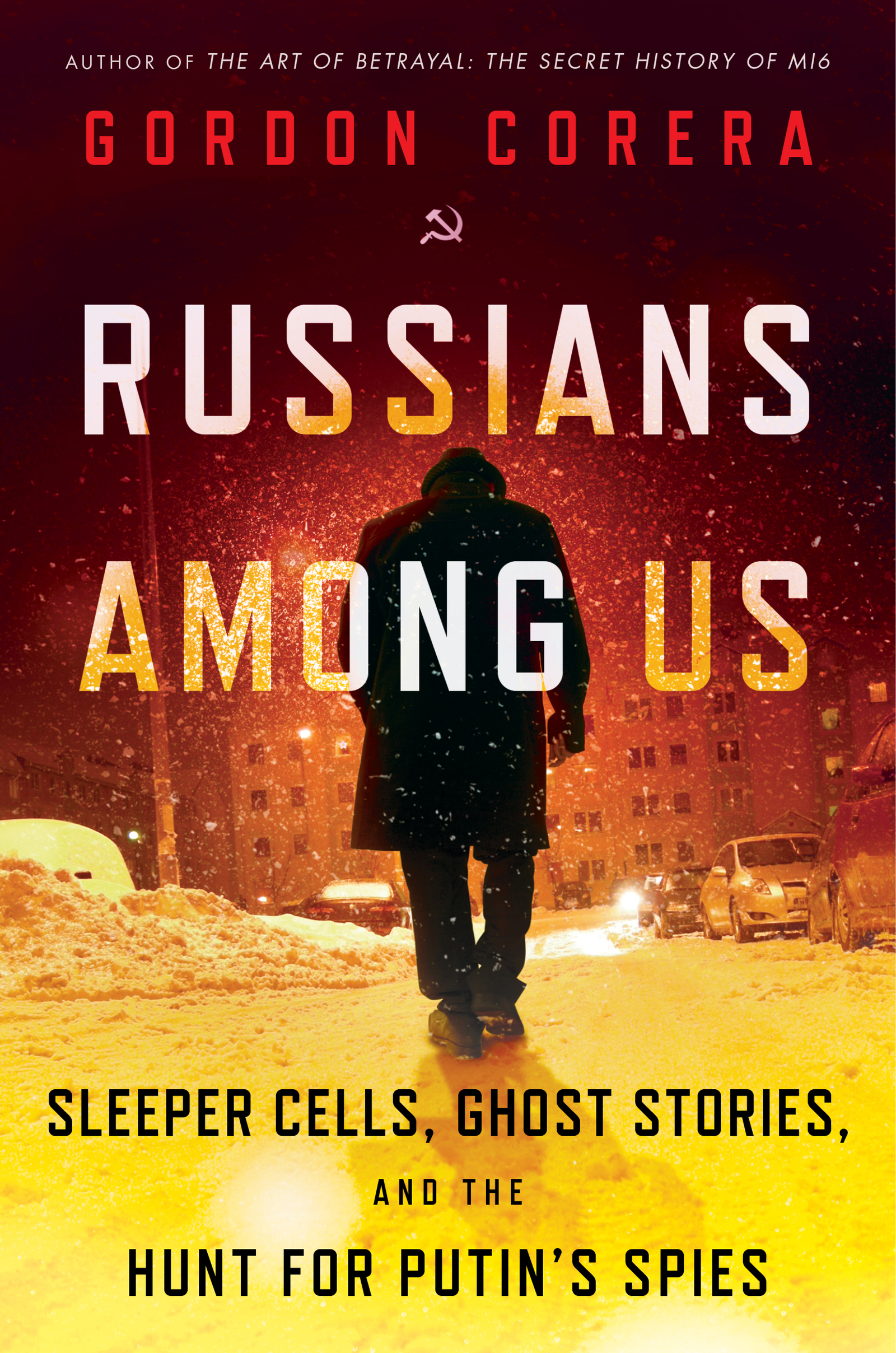
Russians Among Us With intrigue that rivals the best le Carré novels, Russians Among Us tells the explosive story of Russia’s espionage efforts against the United States and the West—from the end of the Cold War to the present and the significant threat of hacking the 2020 election Spies have long been a source of great fascination in the world of fiction, but sometimes the best spy stories happen in real life. Russians Among Us tells the full story of Putin’s escalating espionage campaign in the West, the Russian ‘deep cover’ spies who penetrated the US and the years-long FBI hunt to capture them. This book also details the recruitment, running, and escape of one of the most important spies of modern times, a man who worked inside the heart of Russian intelligence. In this thrilling account Corera tracks not only the history, but the astonishing evolution of Russian espionage, including the use of ‘cyber illegals’ who continue to manipulate us today and pose a significant threat to the 2020 election. Like a scene from the TV drama The Americans, in the summer of 2010 a group of Russian deep cover sleeper agents were arrested. It was the culmination of a decade-long investigation, and ten people, including Anna Chapman, were swapped for four people held in Russia. At the time it was seen simply as a throwback to the Cold War. But that would prove to be a costly mistake. It was a sign that the Russian threat had never gone away and more importantly, it was shifting into a much more disruptive new phase. Today, the danger is clearer than ever following the poisoning in the UK of one of the spies who was swapped, Sergei Skripal, and the growing evidence of Russian interference in American life. Russians Among Us describes for the first time the story of deep cover spies in America and the FBI agents who tracked them. In intimate and riveting detail, it reveals new information about today’s spies—as well as those trying to catch them and those trying to kill them. POLITICAL SCIENCE,Intelligence & Espionage

Homeland Security and Critical Infrastructure Protection, 2nd Edition Since the first edition of this book was published in 2009, significant changes have occurred in the security landscape, both domestically and internationally. This second edition is thoroughly updated to reflect those changes, offering a complete review of the various security and resilience measures currently in place and potential strategies to safeguard life and property within the U.S. homeland. As noted in the U.S. Department of Homeland Security's National Preparedness Goal, the mission area of protection is vital to the homeland in its focus on actions to protect people, vital interests, and our nation's way of life. With that in mind, this book discusses strategies such as risk analysis and assessment, information sharing, and continuity planning. The authors focus on relevant and timely threats and hazards facing specific infrastructure components including, but not limited to, agriculture and food, banking and finance, water, energy, telecommunications, and transportation. The dynamic posture of critical infrastructure security and resilience (CISR) underscores the importance of an integrated, layered all-hazards approach. In describing this approach, the book includes new chapters on planning and guidance, public and private partnerships, cyber issues and threats, and careers in infrastructure protection. Additions such as discussion questions, learning objectives, and fundamental concepts for each chapter provide additional direction for instructors and students alike. POLITICAL SCIENCE,Intelligence & Espionage

Why Intelligence Fails Jervis examines the politics and psychology of two of the more spectacular intelligence failures in recent memory: the mistaken belief that the regime of the Shah in Iran was secure and stable in 1978, and the 2002 claim that Iraq had active WMD programs. POLITICAL SCIENCE,Intelligence & Espionage

Operation Garbo He was GARBO to the Allies and ALARIC to the Germans – the most successful double agent of the Second World War. Indeed, his spy network across Britain was so highly regarded that he was decorated for his achievements … by both sides.Throughout the war, GARBO kept the Germans supplied with reports from his ring of twenty-four agents. Hitler’s spymasters never discovered or even suspected a double-cross, but all the agents in GARBO’s network existed solely in his imagination.In one of the most daring espionage coups of all time, GARBO persuaded the enemy to hold back troops that might otherwise have defeated the Normandy landings on D-Day; without him, the Second World War could have taken a completely different course.For decades, GARBO’s true identity was a closely guarded secret. After the war, he vanished. Years later, after faking his own death, Juan Pujol GarcÃa was persuaded by the author to emerge from the shadowy world of espionage, and in this new edition of his classic account, now updated to include his agents’ original MI5 files, GARBO reveals his unique story. POLITICAL SCIENCE,Intelligence & Espionage
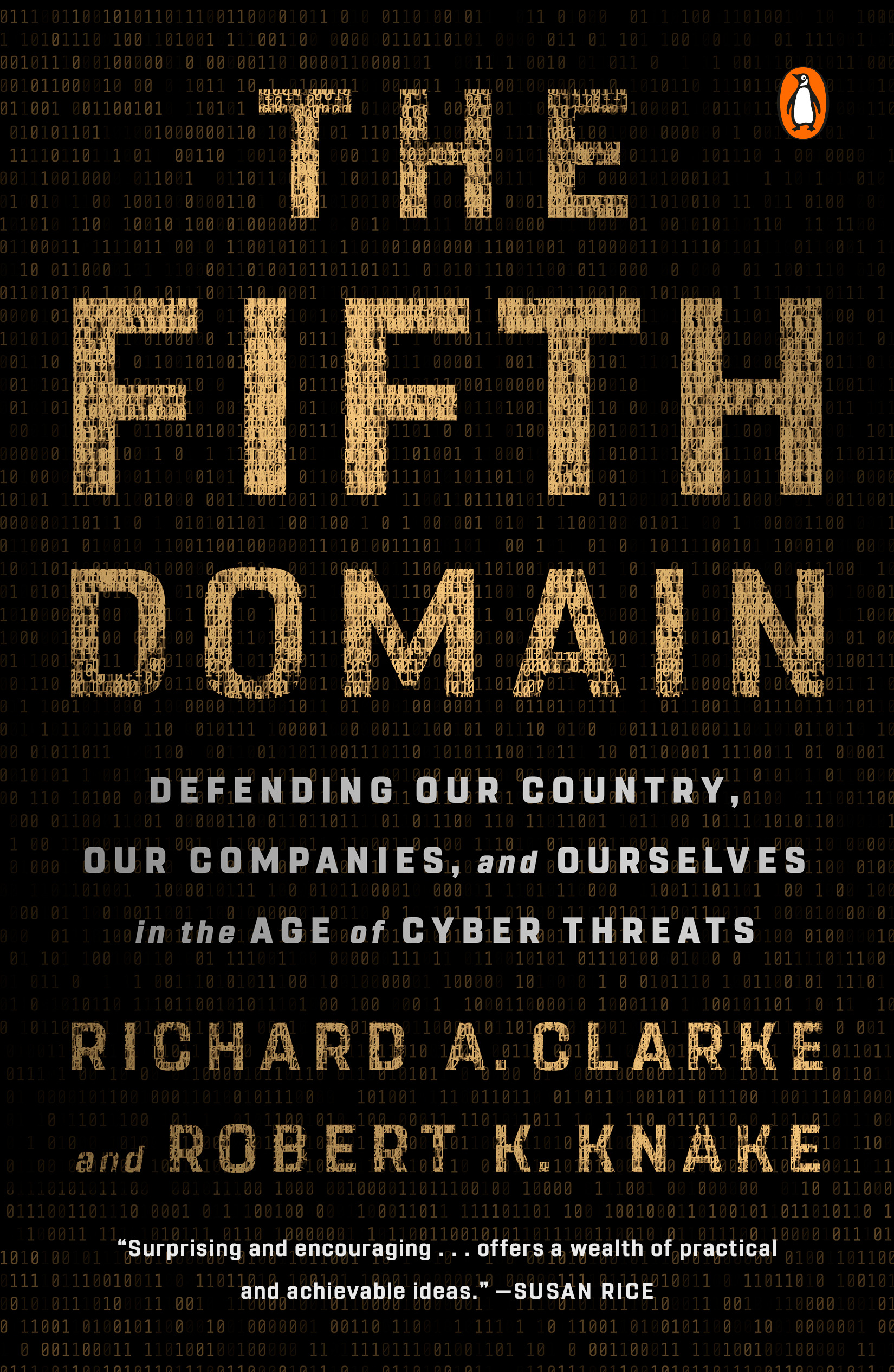
The Fifth Domain An urgent new warning from two bestselling security experts--and a gripping inside look at how governments, firms, and ordinary citizens can confront and contain the tyrants, hackers, and criminals bent on turning the digital realm into a war zone. "In the battle raging between offense and defense in cyberspace, Clarke and Knake have some important ideas about how we can avoid cyberwar for our country, prevent cybercrime against our companies, and in doing so, reduce resentment, division, and instability at home and abroad."--Bill Clinton There is much to fear in the dark corners of cyberspace. From well-covered stories like the Stuxnet attack which helped slow Iran's nuclear program, to lesser-known tales like EternalBlue, the 2017 cyber battle that closed hospitals in Britain and froze shipping crates in Germany in midair, we have entered an age in which online threats carry real-world consequences. But we do not have to let autocrats and criminals run amok in the digital realm. We now know a great deal about how to make cyberspace far less dangerous--and about how to defend our security, economy, democracy, and privacy from cyber attack. This is a book about the realm in which nobody should ever want to fight a war: the fifth domain, the Pentagon's term for cyberspace. Our guides are two of America's top cybersecurity experts, seasoned practitioners who are as familiar with the White House Situation Room as they are with Fortune 500 boardrooms. Richard A. Clarke and Robert K. Knake offer a vivid, engrossing tour of the often unfamiliar terrain of cyberspace, introducing us to the scientists, executives, and public servants who have learned through hard experience how government agencies and private firms can fend off cyber threats. Clarke and Knake take us inside quantum-computing labs racing to develop cyber superweapons; bring us into the boardrooms of the many firms that have been hacked and the few that have not; and walk us through the corridors of the U.S. intelligence community with officials working to defend America's elections from foreign malice. With a focus on solutions over scaremongering, they make a compelling case for "cyber resilience"--building systems that can resist most attacks, raising the costs on cyber criminals and the autocrats who often lurk behind them, and avoiding the trap of overreaction to digital attacks. Above all, Clarke and Knake show us how to keep the fifth domain a humming engine of economic growth and human progress by not giving in to those who would turn it into a wasteland of conflict. Backed by decades of high-level experience in the White House and the private sector, The Fifth Domain delivers a riveting, agenda-setting insider look at what works in the struggle to avoid cyberwar. POLITICAL SCIENCE,Intelligence & Espionage

The Plot to Betray America ***NEW YORK TIMES BESTSELLER*** An Explosive, Revelatory Assessment of the Greatest Betrayal in American History, Newly Revised and Updated William Barr · Paul Manafort · Michael Cohen · Steve Bannon · Rudy Giuliani · Mitch McConnell · Roger Stone · George Papadopoulos · Jeff Sessions · And More! "Impressive... a persuasive whodunit narrative." -Washington Post In The Plot to Betray A merica, New York Times bestselling author and renowned intelligence expert Malcolm Nance reveals exactly how President Trump and his inner circle conspired, coordinated, communicated, and eventually strategized to commit the greatest acts of treachery in the history of the United States: compromising the presidential oath of office in exchange for power and personal enrichment. Seduced by the promises of riches dangled in front of them by Vladimir Putin, the Trump administration eagerly decided to reap the rewards of the plan to put a Kremlin-friendly crony in the Oval Office. Even after his impeachment, Trump continues to defend Putin and jeopardize American intelligence. And instead of interfering, Trump's powerful Republican allies have done everything they can to facilitate Trump's irreparable damage to national security. Through in-depth research and interviews with intelligence experts and insiders, Nance charts Trump's deep financial ties to Russia through his family's investments-including those of Donald Trump Jr., Ivanka Trump, and Jared Kushner-and exposes the corrupt behavior of Trump's other double-crossing pro-Moscow associates. In doing so, Nance also draws a portrait of a venal and selfish president, one who willingly sells American national security to dictators, strongmen, and the ultra-rich at the expense, and sometimes the lives, of American citizens. In this newly revised and updated edition, The Plot to Betray America ultimately sketches the blueprint of the Trump administration's conspiracy against our country-and shows us how we can still fight to defend democracy, protect our national security, and save the Constitution. POLITICAL SCIENCE,Intelligence & Espionage

Proof of Conspiracy Instant New York Times Bestseller "A richly documented indictment of power and corruption." —Kirkus Reviews Through diligent research, Seth Abramson exposes a story that U.S. media has largely missed: a pre-election geopolitical conspiracy involving Saudi Arabia, the United Arab Emirates, Israel, and Russia that sought to put Trump in the White House—and succeeded. In late 2015, convicted pedophile, international dealmaker, and cooperating witness in Special Counsel Robert Mueller’s Russia investigation George Nader convened a secret meeting aboard a massive luxury yacht in the Red Sea. Nader pitched Saudi Crown Prince Mohammed bin Salman, Emirati Crown Prince Mohammed bin Zayed, Egyptian President Abdel Fattah el-Sisi and other Middle Eastern leaders a plan for a new pro-U.S., pro-Israel alliance of Arab nations that would fundamentally alter the geopolitics of the Middle East while marginalizing Iran, Qatar, and Turkey. To succeed, the plan would need a highly placed American politician willing to drop sanctions on Russia so that Vladimir Putin would in turn agree to end his support for Iran. They agreed the perfect American partner was Donald Trump, who had benefited immensely from his Saudi, Emirati, and Russian dealings for many years, and who, in 2015, became the only U.S. presidential candidate to argue for a unilateral end to Russian sanctions and a far more hostile approach to Iran. So begins New York Times bestselling author Seth Abramson’s explosive new book Proof of Conspiracy: How Trump's International Collusion Threatens American Democracy, a story of international intrigue whose massive cast of characters includes Israeli intelligence operatives, Russian oligarchs, Saudi death squads, American mercenary companies, Trump’s innermost circle, and several members of the Trump family as well as Trump himself—all part of a clandestine multinational narrative that takes us from Washington, D.C. and Moscow to the Middle Eastern capitals of Riyadh, Abu Dhabi, Jerusalem, Cairo, Tehran, and Doha. Proof of Conspiracy is a chilling and unforgettable depiction of the dangers America and the world now face. POLITICAL SCIENCE,Intelligence & Espionage
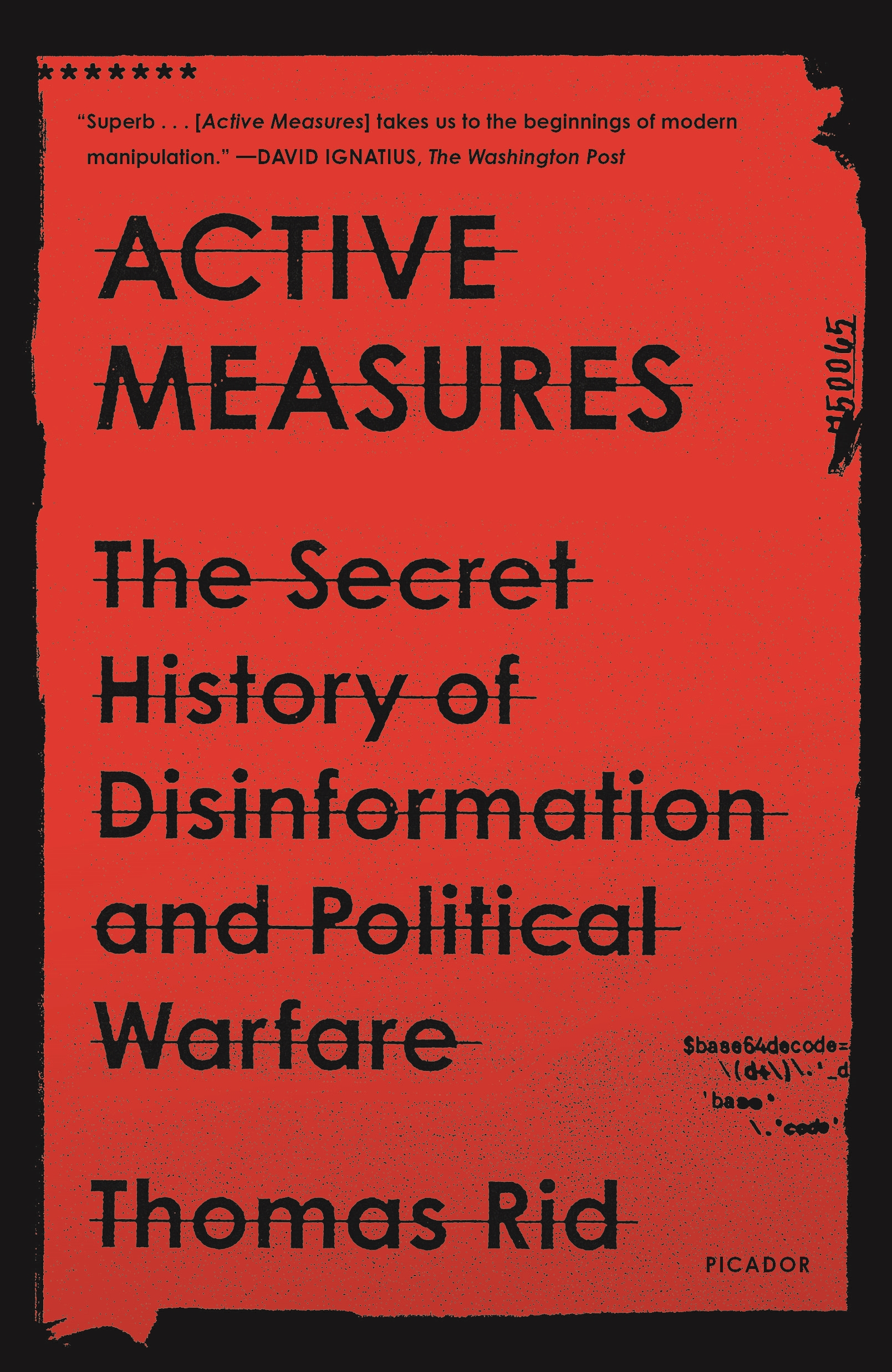
Active Measures This revelatory and dramatic history of disinformation traces the rise of secret organized deception operations from the interwar period to contemporary internet troll farms We live in the age of disinformation—of organized deception. Spy agencies pour vast resources into hacking, leaking, and forging data, often with the goal of weakening the very foundation of liberal democracy: trust in facts. Thomas Rid, a renowned expert on technology and national security, was one of the first to sound the alarm. More than four months before the 2016 election, he warned that Russian military intelligence was “carefully planning and timing a high-stakes political campaign" to disrupt the democratic process. But as crafty as such so-called active measures have become, they are not new. The story of modern disinformation begins with the post-Russian Revolution clash between communism and capitalism, which would come to define the Cold War. In Active Measures, Rid reveals startling intelligence and security secrets from materials written in more than ten languages across several nations, and from interviews with current and former operatives. He exposes the disturbing yet colorful history of professional, organized lying, revealing for the first time some of the century’s most significant operations—many of them nearly beyond belief. A White Russian ploy backfires and brings down a New York police commissioner; a KGB-engineered, anti-Semitic hate campaign creeps back across the Iron Curtain; the CIA backs a fake publishing empire, run by a former Wehrmacht U-boat commander, that produces Germany’s best jazz magazine. Rid tracks the rise of leaking, and shows how spies began to exploit emerging internet culture many years before WikiLeaks. Finally, he sheds new light on the 2016 election, especially the role of the infamous “troll farm†in St. Petersburg as well as a much more harmful attack that unfolded in the shadows. Active Measures takes the reader on a guided tour deep into a vast hall of mirrors old and new, pointing to a future of engineered polarization, more active and less measured—but also offering the tools to cut through the deception. POLITICAL SCIENCE,Intelligence & Espionage
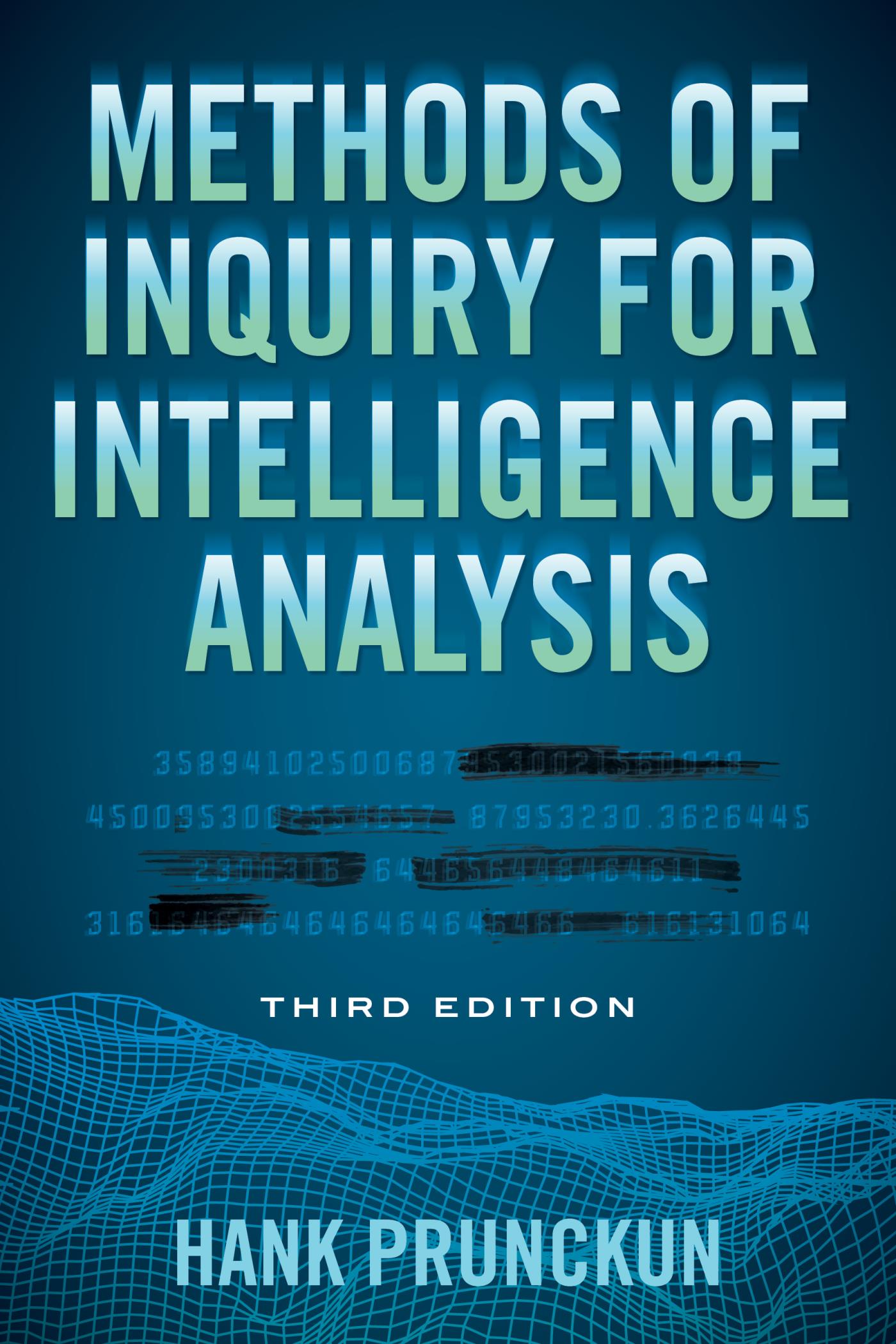
Methods of Inquiry for Intelligence Analysis This book offers students the means of gaining the analytic skills essential to undertake intelligence work, and the understanding of how intelligence fits into the larger research framework. It covers not only the essentials of applied research, but also the function, structure, and operational methods specifically involved in intelligence work. POLITICAL SCIENCE,Intelligence & Espionage

The REAL Benghazi Story Bigger than Watergate! Bigger than Iran-Contra! Ten times bigger than both, said one representative. The Bengahzi scandal may have been covered up by the White House, but the truth is about to come out. The Real Benghazi Story is a ground-breaking investigative work that finally exposes some of the most significant issues related to the murderous September 11, 2012, attack-information with current national security implications. Investigative journalist and New York Times best-selling author Aaron Klein provides the answers many have longed for from the secretive activities transpiring inside the doomed facility to shocking new details about the withholding of critical protection at the U.S. special mission. Learn about what really happened to Ambassador Chris Stevens that fated night, the central role Hillary Clinton actually played in the scandal, and more! Also answered for the first time is why the State Department hired armed members of the al-Qaeda-linked February 17 Martyrs Brigade to protect the facility. New reasons are revealed for not sending air support or Special Forces during the assault, while extensively probing not only jihadist groups but also possible state actors behind the attack. These are just some of the new details to be revealed in this game-changing book. POLITICAL SCIENCE,Intelligence & Espionage

Dead Doubles The astonishing but true story of one of the most notorious spy cases from the Cold War—and the international manhunt that seized global attention as it revealed the shadowy world of deep cover KGB operatives. The dramatic arrest in London on January 7, 1961 of five Soviet spies made headlines worldwide and had repercussions around the globe. Alerted by the CIA, Britain's security service, MI5, had discovered two British spies stealing invaluable secrets from the highly sensitive submarine research center at Portland, UK. Their controller, Gordon Lonsdale, was a Canadian who frequently visited a middle-aged couple, the Krogers, in their sleepy London suburb. But the seemingly unassuming Krogers were revealed to be deep cover American KGB spies—infamous undercover agents the FBI had been hunting for years—and they were just one part of an extensive network of Soviet operatives in the UK. In the wake of the spies' sensational trial, the FBI uncovered the true identity of the enigmatic Lonsdale—Konon Molody, a Russian who had lived in California before being recruited by the KGB. Molody opened secret talks with MI5 to betray Russia, but before he had the chance, the KGB blackmailed Britain into spy swaps for him and the Krogers. Based on revelatory, newly-released archival material and inside sources from around the world, Dead Doubles follows the hunt for the highly damaging Portland Spy Ring. As gripping as a le Carré novel, this incredible narrative, layered with false identities, deceptions, and betrayal, crisscrosses from the UK to the USSR to the US, Canada, Europe and New Zealand, and brings to life one of the most extraordinary spy stories of the Cold War. POLITICAL SCIENCE,Intelligence & Espionage
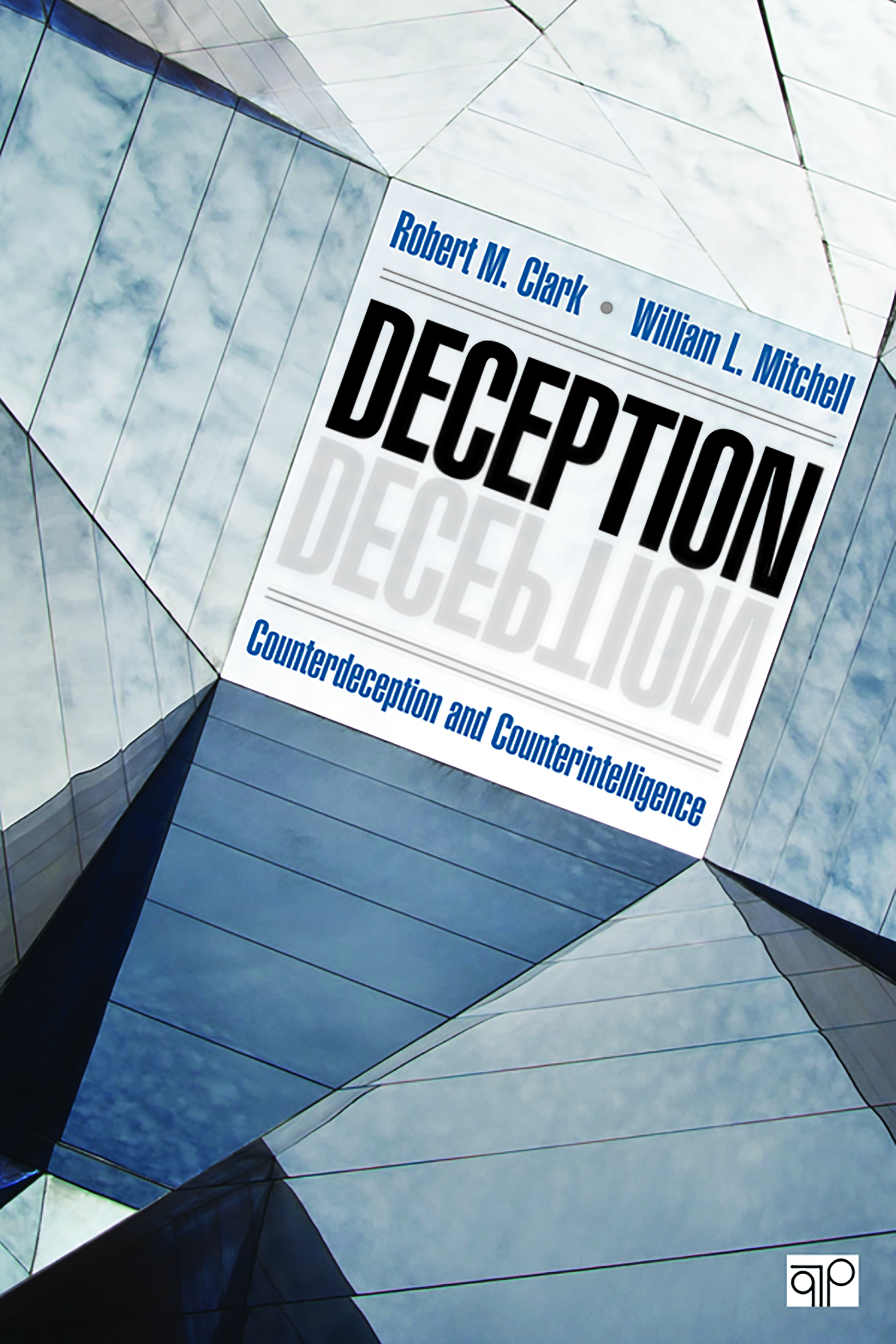
Deception Bridging the divide between theory and practice, Deception: Counterdeception and Counterintelligence provides a thorough overview of the principles of deception and its uses in intelligence operations. This masterful guide focuses on practical training in deception for both operational planners and intelligence analysts using a case-based approach. Authors Robert M. Clark and William L. Mitchell draw from years of professional experience to offer a fresh approach to the roles played by information technologies such as social media. By reading and working through the exercises in this text, operations planners will learn how to build and conduct a deception campaign, and intelligence analysts will develop the ability to recognize deception and support deception campaigns. Key Features New channels for deception, such as social media, are explored to show you how to conduct and detect deception activities through information technology. Multichannel deception across the political, military, economic, social, infrastructure, and information domains provides you with insight into the variety of ways deception can be used as an instrument for gaining advantage in conflict. Contemporary and historical cases simulate real-world raw intelligence and provide you with opportunities to use theory to create a successful deception operation. A series of practical exercises encourages you to think critically about each situation. The exercises have several possible answers, and conflicting raw material is designed to lead readers to different answers depending on how the reader evaluates the material. Individual and team assignments offer you the flexibility to proceed through the exercises in any order and assign exercises based on what works best for the classroom setup. POLITICAL SCIENCE,Intelligence & Espionage
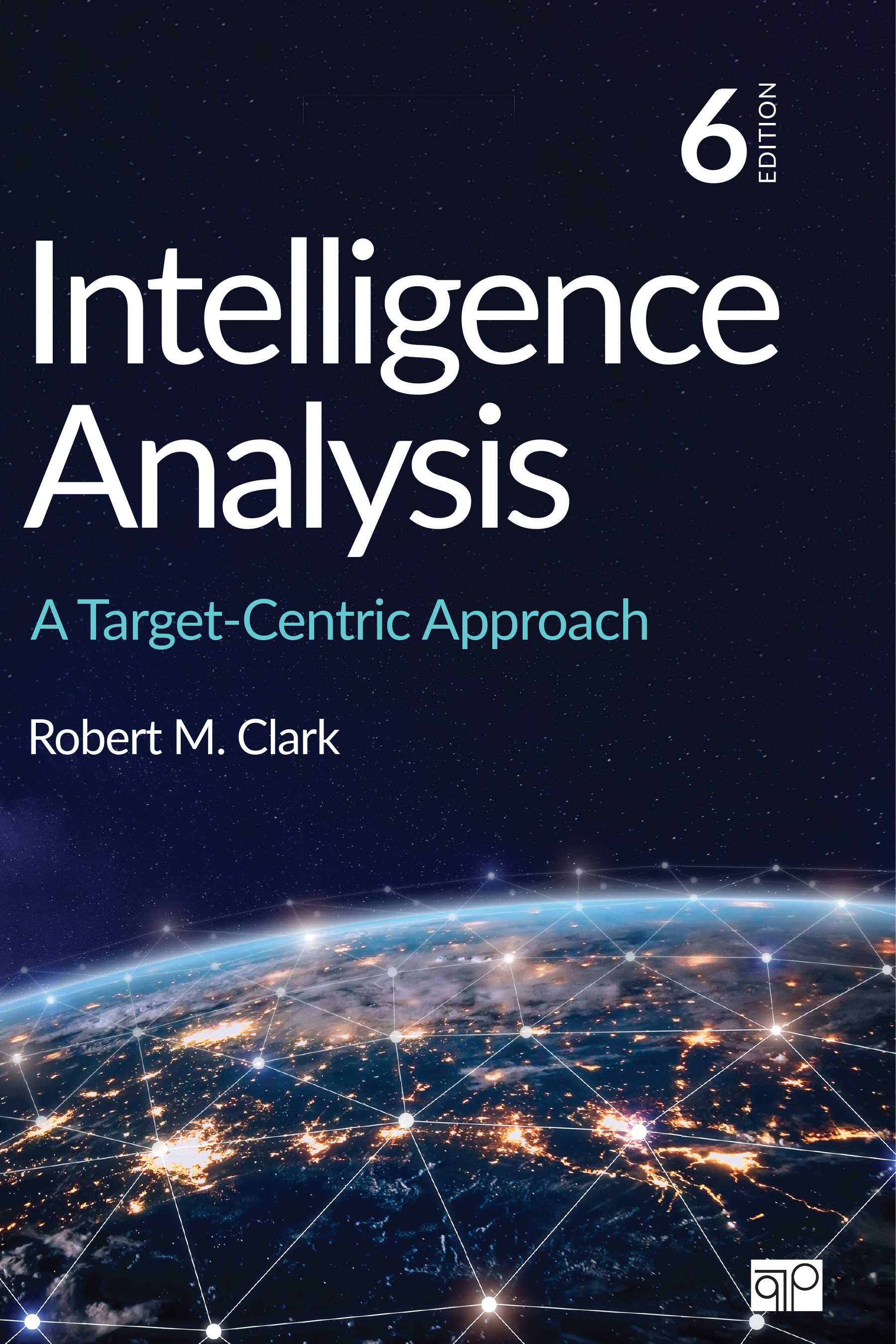
Intelligence Analysis Now in its Sixth Edition, Robert M. Clark's Intelligence Analysis: A Target-Centric Approach once again delivers a consistent, clear method for teaching intelligence analysis—demonstrating how a collaborative, target-centric approach leads to sharper and more effective analysis. This bestseller also includes new end-of-chapter questions to spark classroom discussion, as well as material on the intelligence cycle, collection, managing analysis, and dealing with intelligence customers. Clark’s practical approach combined with his insider perspective create the ideal resource for students and practitioners alike. POLITICAL SCIENCE,Intelligence & Espionage

Intelligence Mark M. Lowenthal’s trusted guide is the go-to resource for understanding how the intelligence community’s history, structure, procedures, and functions affect policy decisions. In the fully updated Eighth Edition of Intelligence, the author addresses cyber security and cyber intelligence throughout, expands the coverage of collection, comprehensively updates the chapters on nation-state issues and transnational issues, and looks at foreign intelligence services, both large and small. POLITICAL SCIENCE,Intelligence & Espionage
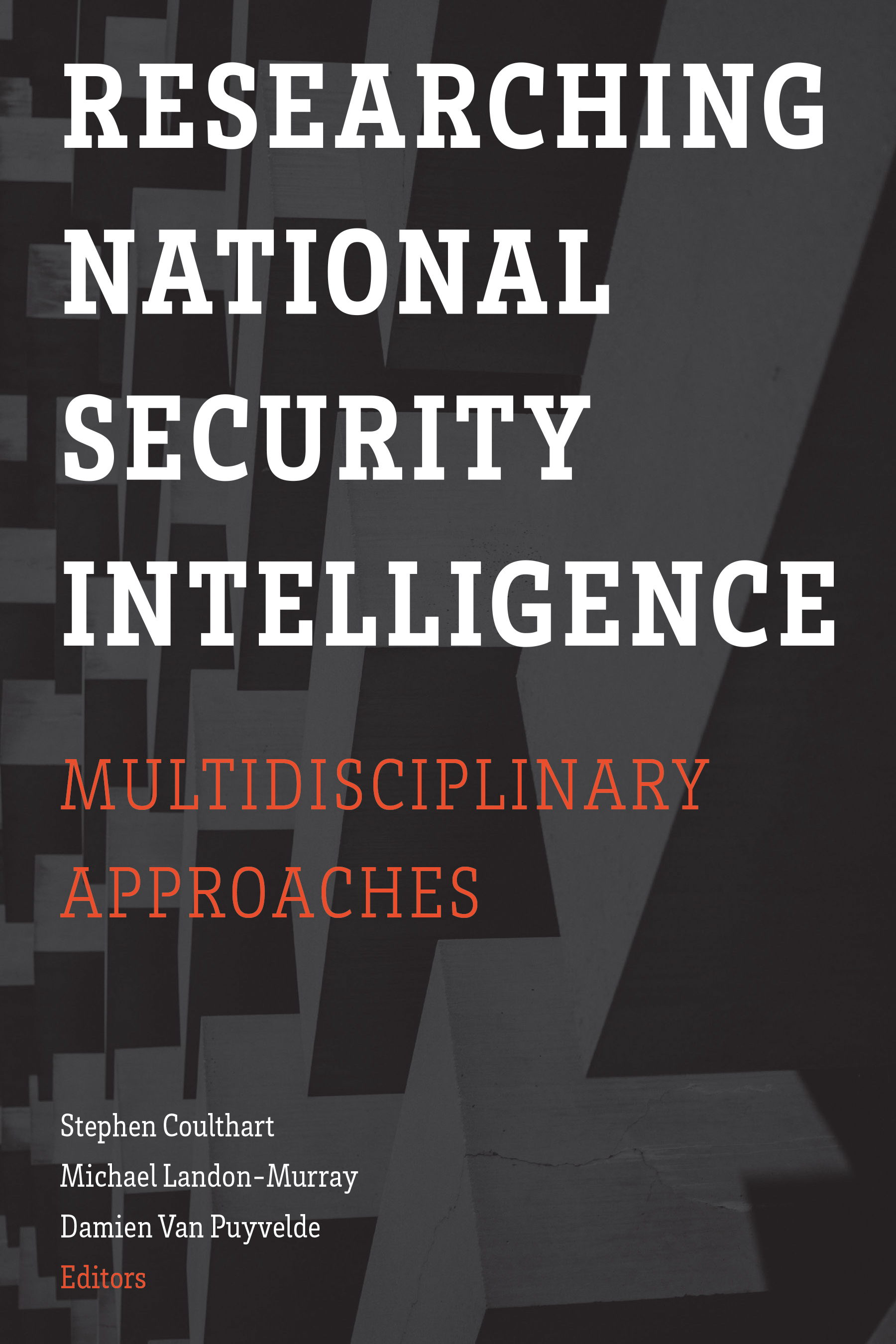
Researching National Security Intelligence Researchers in the rapidly growing field of intelligence studies face unique and difficult challenges ranging from finding and accessing data on secret activities, to sorting through the politics of intelligence successes and failures, to making sense of complex socio-organizational or psychological phenomena. The contributing authors to Researching National Security Intelligence survey the state of the field and demonstrate how incorporating multiple disciplines helps to generate high-quality, policy-relevant research. Following this approach, the volume provides a conceptual, empirical, and methodological toolkit for scholars and students informed by many disciplines: history, political science, public administration, psychology, communications, and journalism. This collection of essays written by an international group of scholars and practitioners propels intelligence studies forward by demonstrating its growing depth, by suggesting new pathways to the creation of knowledge, and by identifying how scholarship can enhance practice and accountability. POLITICAL SCIENCE,Intelligence & Espionage

The Strength of the Wolf The Strength of the Wolf is the first complete history of the Federal Bureau of Narcotics (1930–1968). Working undercover around the globe, the FBN's charismatic “case-making” agents penetrated the Mafia and its French connection. In the process, however, they uncovered the national security establishment's ties to organized crime. Victims of their freewheeling methods and unparalleled success in hunting down society's predators, the agents were ultimately targeted for destruction by the FBI and CIA. Based largely on interviews with case-making agents, The Strength of the Wolf provides a new, exciting, and revealing chapter in American history. POLITICAL SCIENCE,Intelligence & Espionage
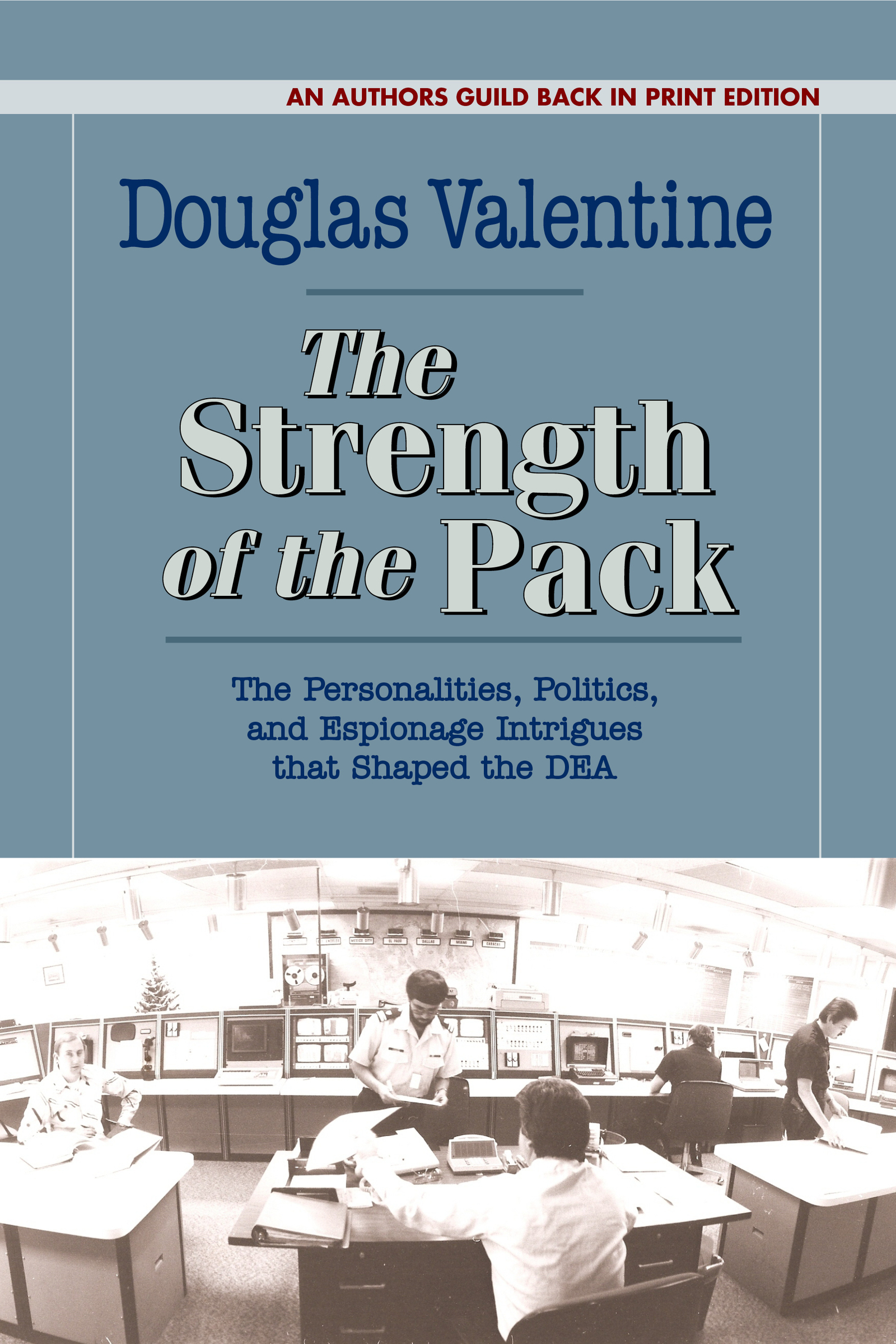
The Strength of the Pack The Strength of the Pack documents previously unknown aspects of the history of federal drug law enforcement, from the formation of the Bureau of Narcotics and Dangerous Drugs in 1968 through the early years of the Drug Enforcement Administration. Picking up where The Strength of the Wolf left off, the book shows how successive administrations expanded federal drug law enforcement operations under the pervasive but hidden influence of the CIA. The “wolf pack” is a metaphor for the multitude of agencies and their offshoots that comprise the labyrinth system currently waging the eternal war on drugs. Once upon a time, the “lone wolf” federal narcotics agent, last of the noir detectives, hard-boiled and streetwise, stalked his prey: vicious Mafia drug dealers and their international connections. But the rise of the American Superpower and the opium-infused Vietnam War saw the lone wolf replaced by a dehumanized bureaucratic system more suitable to empire: the wolf pack, secretly led by the CIA and designed specifically for using the war on drugs as a covert means of advancing the interests of the U.S. ruling class at home and abroad. Based largely on interviews with former federal narcotics agents and CIA officers, as well as the influential politicians and government bureaucrats they worked with, The Strength of the Pack focuses on the CIA's steady infiltration and corruption of federal drug law enforcement for the purpose of waging political and psychological warfare against the American public. Many books have focused on the public policy aspects of federal drug law enforcement, but no book to date has plumbed as deeply into the secret policies, or taken as comprehensive a view of them, as this one. POLITICAL SCIENCE,Intelligence & Espionage

The New Era in U.S. National Security The second edition of The New Era offers students and instructors a whole cloth, insightful perspective on the dynamic, changing patterns and orientations unleashed by the processes of globalization, technology, and the emerging “Second Cold War†era. POLITICAL SCIENCE,Intelligence & Espionage
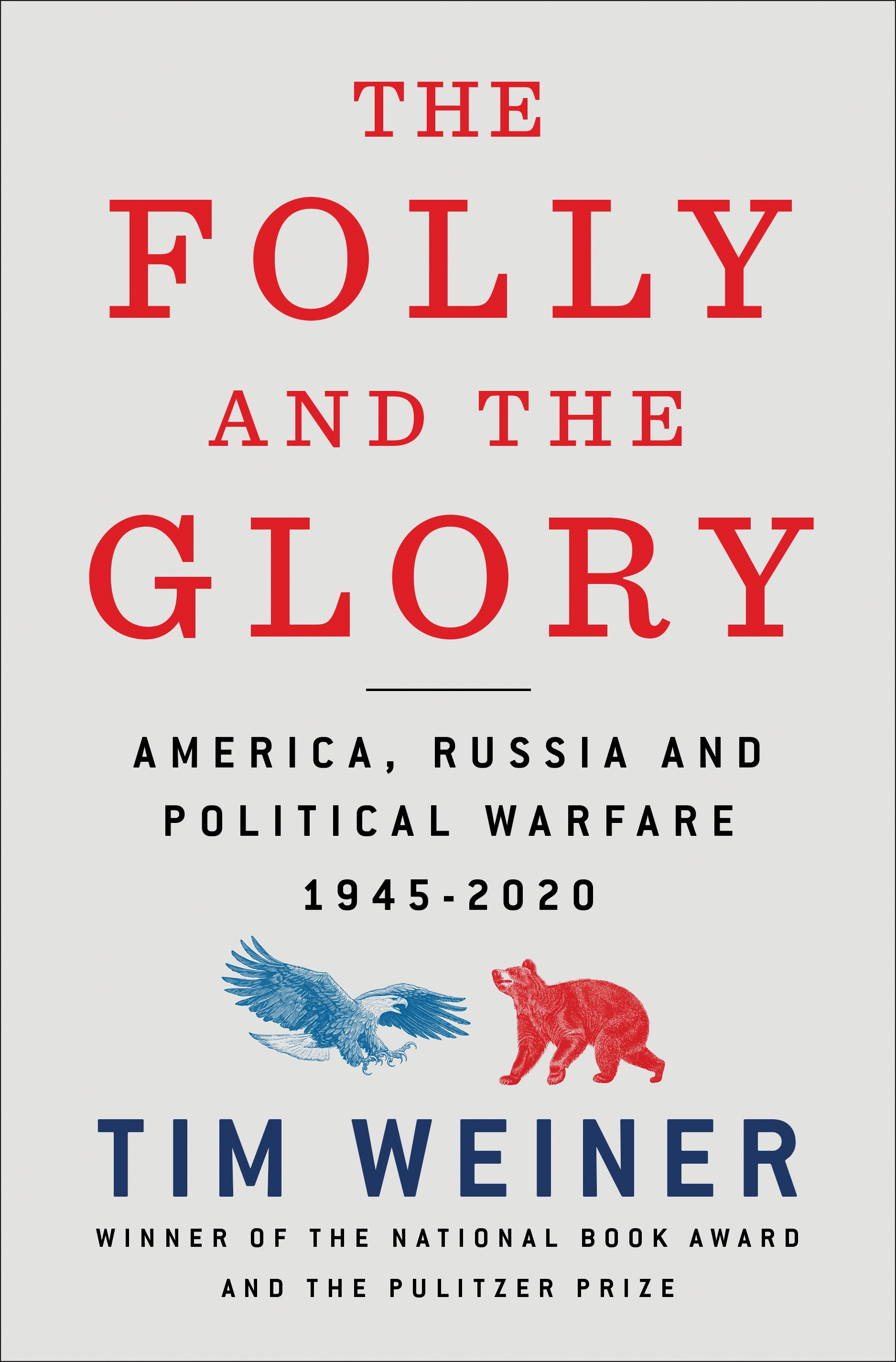
The Folly and the Glory From Tim Weiner, winner of the Pulitzer Prize and the National Book Award, an urgent and gripping account of the 75-year battle between the US and Russia that led to the election and impeachment of an American president. With vivid storytelling and riveting insider accounts, Weiner traces the roots of political warfare – the conflict America and Russia have waged with espionage, sabotage, diplomacy and disinformation – from 1945 until 2020. America won the cold war, but Russia is winning today. Vladimir Putin helped to put his chosen candidate in the White House with a covert campaign that continues to this moment. Putin’s Russia has revived Soviet-era intelligence operations gaining ever more potent information from—and influence over—the American people and government. Yet the US has put little power into its defense. This has put American democracy in peril. Weiner takes us behind closed doors, illuminating Russian and American intelligence operations and their consequences. To get to the heart of what is at stake and find potential solutions, he examines long-running 20th century CIA operations, the global political machinations of the Soviet KGB around the world, the erosion of American political warfare after the Cold War, and how 21st century Russia has kept the cold war alive. The Folly and the Glory is an urgent call to our leaders and citizens to understand the nature of political warfare – and to change course before it’s too late. POLITICAL SCIENCE,Intelligence & Espionage
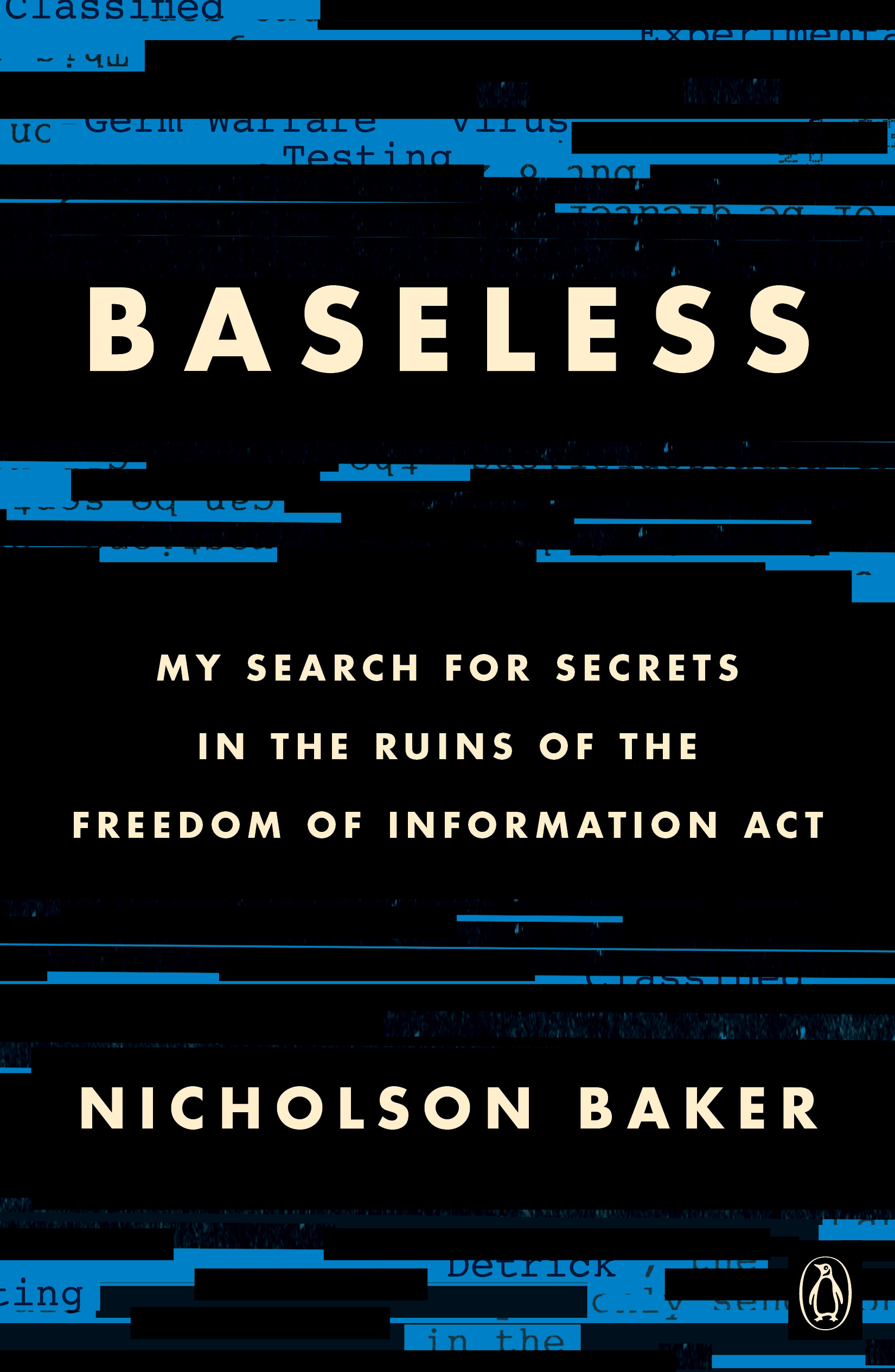
Baseless A major new work, a hybrid of history, journalism, and memoir, about the modern Freedom of Information Act – FOIA – and the horrifying, decades-old government misdeeds that it is unable to demystify, from one of America's most celebrated writers Eight years ago, while investigating the possibility that the United States had used biological weapons in the Korean War, Nicholson Baker requested a series of Air Force documents from the early 1950s under the provisions of the Freedom of Information Act. Years went by, and he got no response. Rather than wait forever, Baker set out to keep a personal journal of what it feels like to try to write about major historical events in a world of pervasive redactions, witheld records, and glacially slow governmental responses. The result is one of the most original and daring works of nonfiction in recent memory, a singular and mesmerizing narrative that tunnels into the history of some of the darkest and most shameful plans and projects of the CIA, the Air Force, and the presidencies of Harry Truman and Dwight Eisenhower. In his lucid and unassuming style, Baker assembles what he learns, piece by piece, about Project Baseless, a crash Pentagon program begun in the early fifties that aimed to achieve "an Air Force-wide combat capability in biological and chemical warfare at the earliest possible date." Along the way, he unearths stories of balloons carrying crop disease, leaflet bombs filled with feathers, suicidal scientists, leaky centrifuges, paranoid political-warfare tacticians, insane experiments on animals and humans, weaponized ticks, ferocious propaganda battles with China, and cover and deception plans meant to trick the Kremlin into ramping up its germ-warfare program. At the same time, Baker tells the stories of the heroic journalists and lawyers who have devoted their energies to wresting documentary evidence from goverment repositories, and he shares anecdotes from his daily life in Maine feeding his dogs and watching the morning light gather on the horizon. The result is an astonishing and utterly disarming story about waiting, bureaucracy, the horrors of war, and, above all, the cruel secrets that the United States government seems determined to keep forever from its citizens. POLITICAL SCIENCE,Intelligence & Espionage

Intelligence in the National Security Enterprise This textbook introduces students to the critical role of the US intelligence community within the wider national security decision-making and political process. Intelligence in the National Security Enterprise defines what intelligence is and what intelligence agencies do, but the emphasis is on showing how intelligence serves the policymaker. Roger Z. George draws on his thirty-year CIA career and more than a decade of teaching at both the undergraduate and graduate level to reveal the real world of intelligence. Intelligence support is examined from a variety of perspectives to include providing strategic intelligence, warning, daily tactical support to policy actions as well as covert action. The book includes useful features for students and instructors such as excerpts and links to primary-source documents, suggestions for further reading, and a glossary. POLITICAL SCIENCE,Intelligence & Espionage
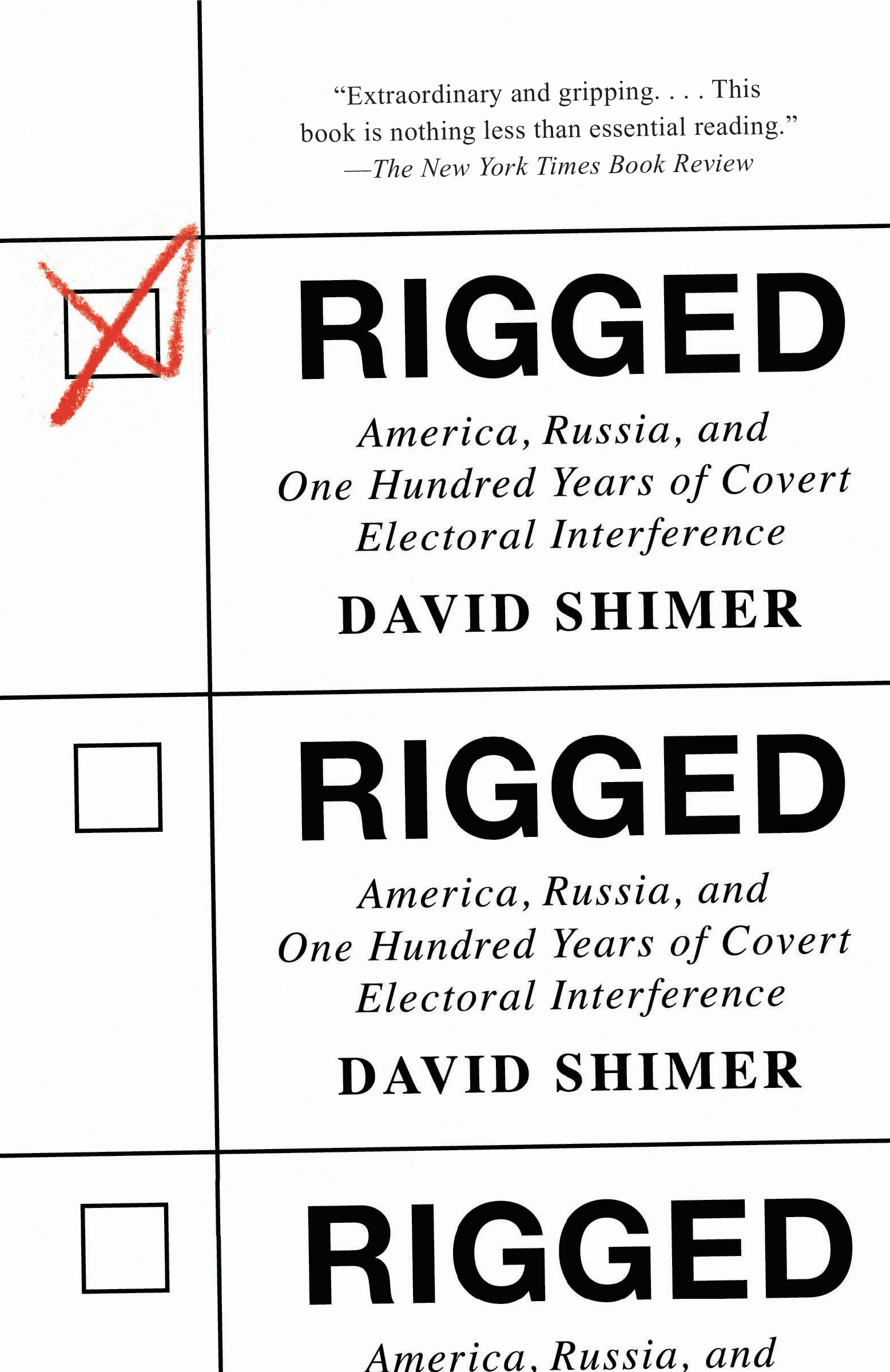
Rigged NAMED A NEW YORK TIMES EDITORS' CHOICE BOOK "The first book to put the story of Russian interference into a broader context. . . Extraordinary and gripping. . . With the pacing of a thriller and the insight of a superb work of history. . . this book is nothing less than essential reading. --Tim Naftali, The New York Times Book Review The definitive history of the covert struggle between Russia and America to influence elections, why the threat to American democracy is greater than ever in 2020, and what we can do about it. Russia's interference in 2016 marked only the latest chapter of a hidden and revelatory history. In Rigged, David Shimer tells the sweeping story of covert electoral interference past and present. He exposes decades of secret operations--by the KGB, the CIA, and Vladimir Putin's Russia--to shape electoral outcomes, melding deep historical research with groundbreaking interviews with more than 130 key players, from leading officials in both the Trump and Obama administrations, to CIA and NSA directors, to a former KGB general. What Americans should make of Russia's attack in 2016 is still hotly debated, even after the Mueller report and years of media coverage. Shimer shows that Putin's operation was, in fact, a continuation of an ongoing struggle, using familiar weapons radically enhanced by new technology. Throughout history and in 2016, both Russian and American operations achieved their greatest success by influencing the way voters think, rather than tampering with actual vote tallies. Casting aside partisanship and sensationalism, Rigged reveals new details about what Russia achieved in 2016, how the Obama administration responded, and why Putin has also been interfering covertly in elections across the globe in recent years, while American presidents have largely refrained from doing so. Shimer also makes disturbingly clear that this type of intrusion can be used to harm Democrats and Republicans alike. Russia's central aim is to undermine and disrupt our democracy, to the detriment of all Americans. Understanding 2016 as one battle in a much longer war is essential to understanding the critical threat currently posed to America's electoral sovereignty and how to defend against it. Illuminating how the lessons of the past can be used to protect our democracy in the future, Rigged is an essential book for readers of every political persuasion. POLITICAL SCIENCE,Intelligence & Espionage

October Surprise The 2016 Election, which altered American political history, was not decided by the Russians or in Ukraine or by Steve Bannon. The event that broke Hillary's blue wall in the Midwest and swung Florida and North Carolina was an October Surprise, and it was wholly a product of the leadership of the FBI. This is the inside story by the reporter closest to its center. In September 2016, Hillary Clinton was the presumptive next president of the US. She had a blue wall of states leaning her way in the Midwest, and was ahead in North Carolina and Florida, with a better than even shot at taking normally Republican Arizona. The US was about to get its first woman president. Yet within two months everything was lost. An already tightening race saw one seismic correction: it came in October when the FBI launched an investigation into the Clinton staff's use of a private server for their emails. Clinton fell 3-4 percent in the polls instantly, and her campaign never had time to rebut the investigation or rebuild her momentum so close to election day. The FBI cost her the race. October Surprise is a pulsating narrative of an agency seized with righteous certainty that waded into the most important political moment in the life of the nation, and has no idea how to back out with dignity. So it doggedly stands its ground, compounding its error. In a momentous display of self-preservation, James Comey, Andrew McCabe, and key Justice Department officials decide to protect their own reputations rather than save the democratic process. Once they make that determination, the race is lost for Clinton, who is helpless in front of their accusation even though she has not intended to commit, let alone actually committed, any crime. A dark true-life thriller with historic consequences set at the most crucial moment in the electoral calendar, October Surprise is a warning, a morality tale and a political and personal tragedy. POLITICAL SCIENCE,Intelligence & Espionage

A Practical Introduction to Homeland Security The book gives a practical introduction to the concepts, structure, politics, law, hazards, threats, and practices of homeland security everywhere, focusing on US “homeland security,†Canadian “public safety,†and European “domestic security.†It is a conceptual and practical textbook, not a theoretical work. POLITICAL SCIENCE,Intelligence & Espionage

Head of the Mossad Shabtai Shavit, director of the Mossad from 1989 to 1996, is one of the most influential leaders to shape the recent history of the State of Israel. In this exciting and engaging book, Shavit combines memoir with sober reflection to reveal what happened during the seven years he led what is widely recognized today as one of the most powerful and proficient intelligence agencies in the world. Shavit provides an inside account of his intelligence and geostrategic philosophy, the operations he directed, and anecdotes about his family, colleagues, and time spent in, among other places, the United States as a graduate student and at the CIA. Shavit’s tenure occurred during many crucial junctures in the history of the Middle East, including the collapse of the Soviet Union and the end of the Cold War era; the first Gulf War and Prime Minister Yitzhak Shamir’s navigation of the state and the Israeli Defense Forces (IDF) during the conflict; the peace agreement with Jordan, in which the Mossad played a central role; and the assassination of Prime Minister Yitzhak Rabin. Shavit offers a broad sweep of the integral importance of intelligence in these historical settings and reflects on the role that intelligence can and should play in Israel's future against Islamist terrorism and Iran’s eschatological vision. Head of the Mossad is a compelling guide to the reach of and limits facing intelligence practitioners, government officials, and activists throughout Israel and the Middle East. This is an essential book for everyone who cares for Israel’s security and future, and everyone who is interested in intelligence gathering and covert action. POLITICAL SCIENCE,Intelligence & Espionage
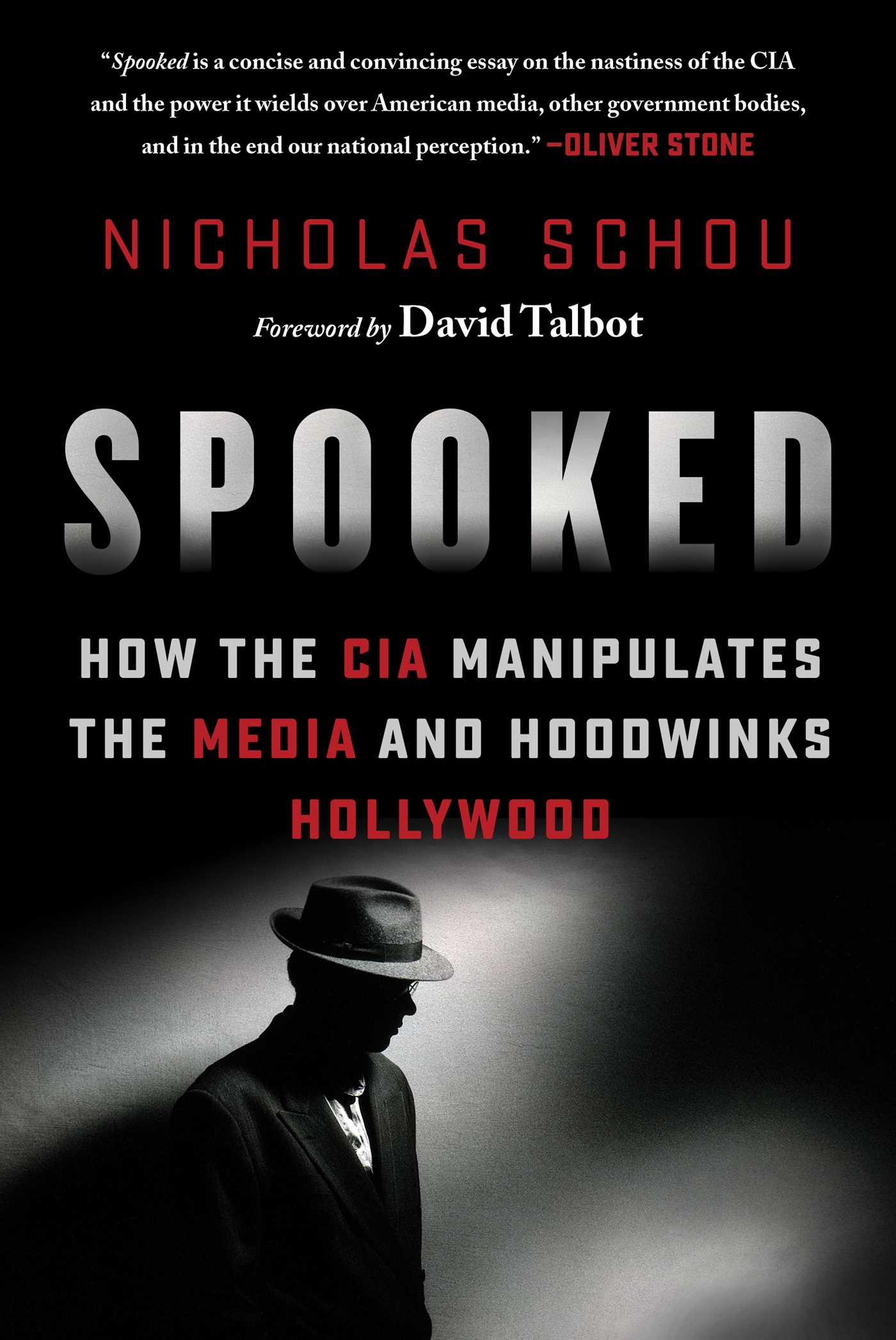
Spooked The American people depend on a free press to keep a close and impartial watch on the national security operations that are carried out in our name. But in many cases, this trust is sadly misplaced, as leading journalists are seduced and manipulated by the secretive agencies they cover. While the press remains silent about its corrupting relationship with the intelligence communitya relationship that dates back to the Cold WarSpooking the News will blow the lid off this unseemly arrangement. Schou will name names and shine a spotlight on flagrant examples of collusion, when respected reporters have crossed the line and sold out to powerful agencies. The book will also document how the CIA has embedded itself in liberal†Hollywood to ensure that its fictional spies get the hero treatment on screen. Among the revelations in Spooking the News: The CIA created a special public affairs unit to influence the production of Hollywood films and TV shows, allowing celebrities involved in pro-CIA projectsincluding Harrison Ford and Ben Affleckunique access inside the agency's headquarters. The CIA vets articles on controversial topics like the drone assassination program and grants friendly reporters background briefings on classified material, while simultaneously prosecuting ex-officers who spill the beans on damaging information. POLITICAL SCIENCE,Intelligence & Espionage
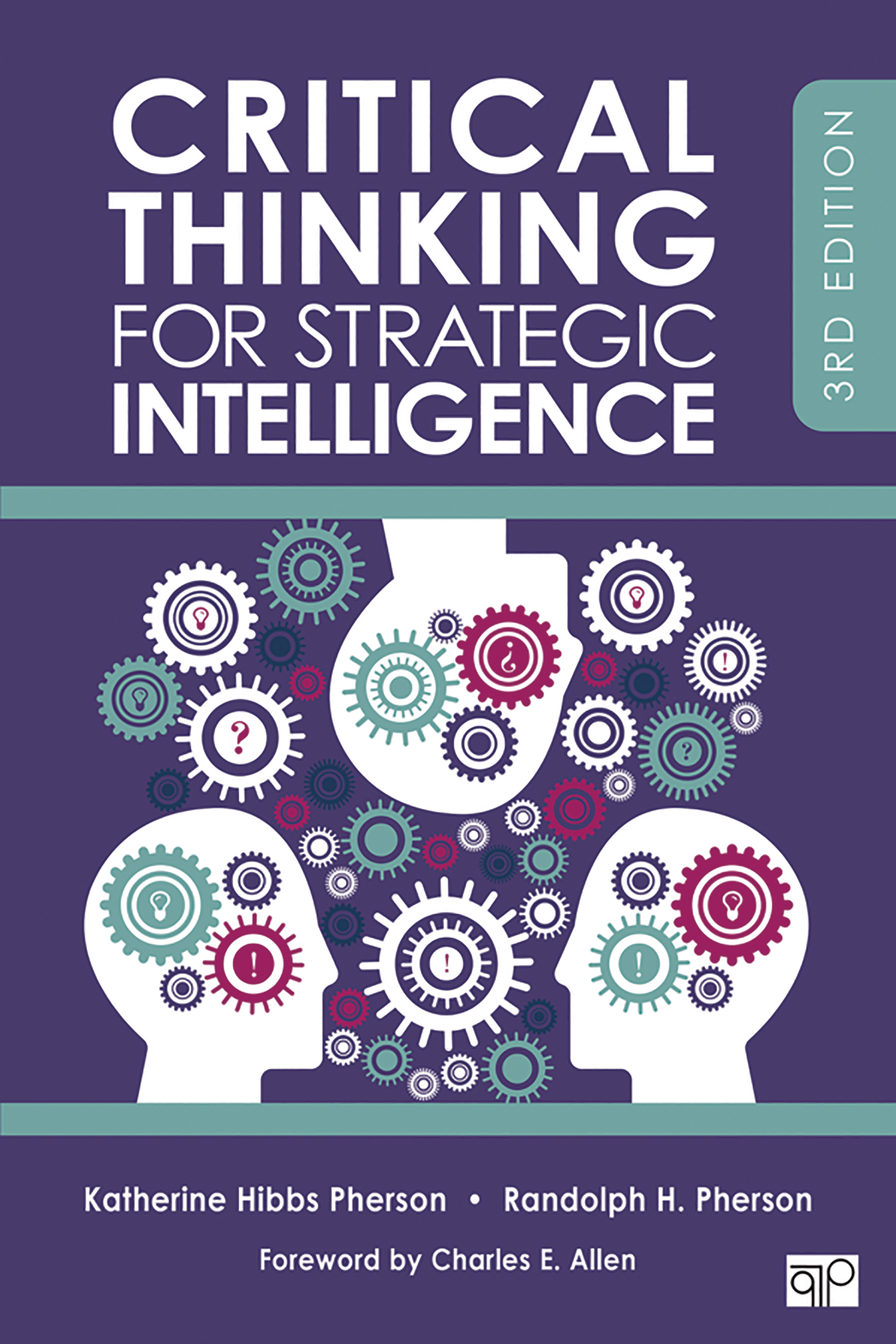
Critical Thinking for Strategic Intelligence With Critical Thinking for Strategic Intelligence , Katherine Hibbs Pherson and Randolph H. Pherson have updated their highly regarded, easy-to-use handbook for developing core critical thinking skills and analytic techniques. This indispensable text is framed around 20 key questions that all analysts must ask themselves as they prepare to conduct research, generate hypotheses, evaluate sources of information, draft papers, and ultimately present analysis, including: How do I get started? Where is the information I need? What is my argument? How do I convey my message effectively? The Third Edition includes suggested best practices for dealing with digital disinformation, politicization, and AI. Drawing upon their years of teaching and analytic experience, Pherson and Pherson provide a useful introduction to skills that are essential within the intelligence community. POLITICAL SCIENCE,Intelligence & Espionage
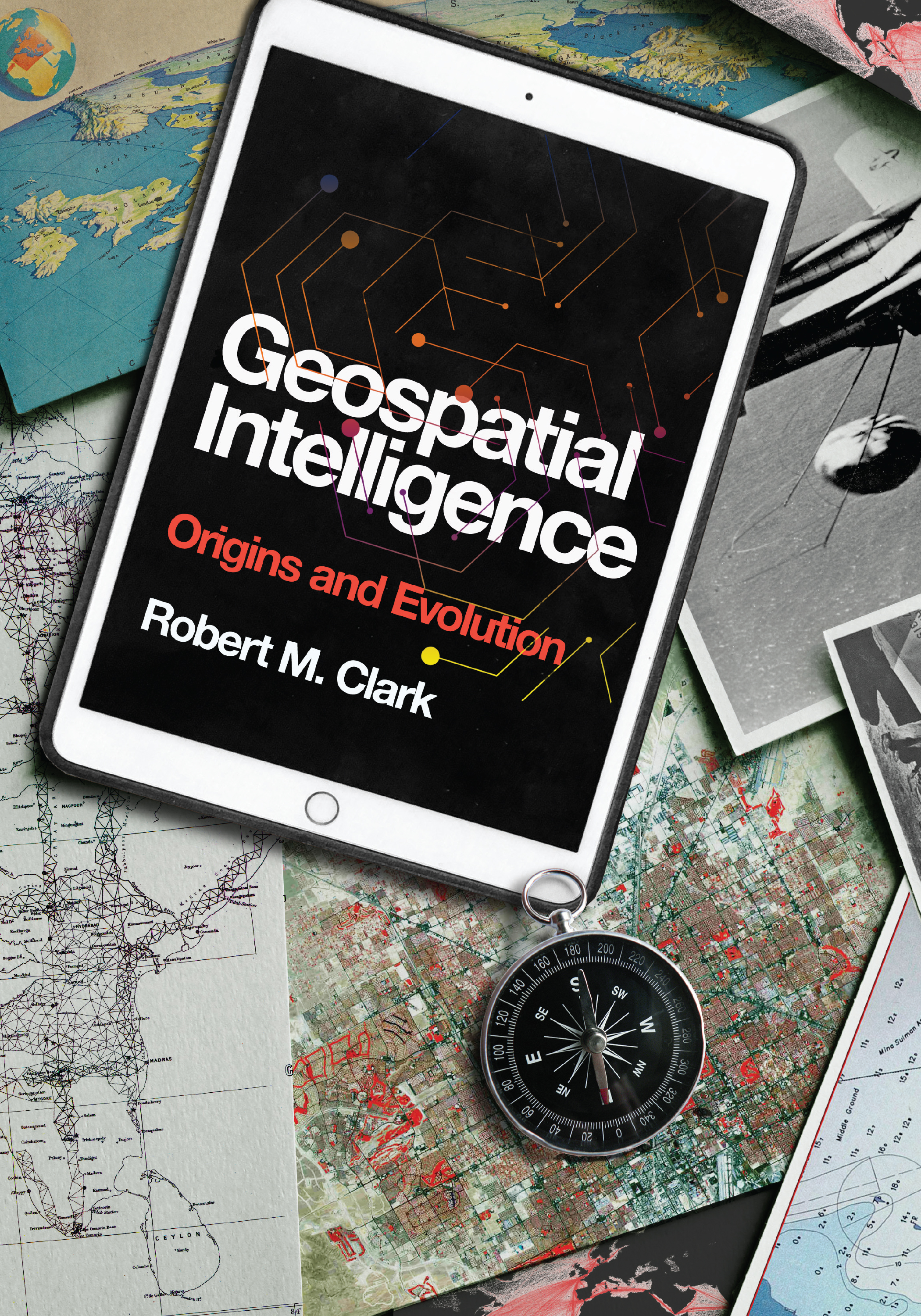
Geospatial Intelligence A riveting introduction to the complex and evolving field of geospatial intelligence, Geospatial Intelligence: Origins and Evolutions tells the story of how the current age of geospatial knowledge evolved from its ancient origins to become ubiquitous in daily life across the globe. POLITICAL SCIENCE,Intelligence & Espionage

Hitler's Generals in America Americans are familiar with prisoner of war narratives that detail Allied soldiers' treatment at the hands of Germans in World War II: popular books and movies like The Great Escape and Stalag 17 have offered graphic and award-winning depictions of the American POW experience in Nazi camps. Less is known, however, about the Germans captured and held in captivity on U.S. soil during the war. In Hitler's Generals in America, Derek R. Mallett examines the evolution of the relationship between American officials and the Wehrmacht general officers they held as prisoners of war in the United States between 1943 and 1946. During the early years of the war, British officers spied on the German officers in their custody, housing them in elegant estates separate from enlisted soldiers, providing them with servants and cooks, and sometimes becoming their confidants in order to obtain intelligence. The Americans, on the other hand, lacked the class awareness shared by British and German officers. They ignored their German general officer prisoners, refusing them any special treatment. By the end of the war, however, the United States had begun to envision itself as a world power rather than one of several allies providing aid during wartime. Mallett demonstrates how a growing admiration for the German officers' prowess and military traditions, coupled with postwar anxiety about Soviet intentions, drove Washington to collaborate with many Wehrmacht general officers. Drawing on newly available sources, this intriguing book vividly demonstrates how Americans undertook the complex process of reconceptualizing Germans -- even Nazi generals -- as allies against what they perceived as their new enemy, the Soviet Union. POLITICAL SCIENCE,Intelligence & Espionage

More Stories from Langley A collection of personal essays detailing the adventures, advice, and experience of generations of CIA analytic, operational, support and technical officers and managers. POLITICAL SCIENCE,Intelligence & Espionage
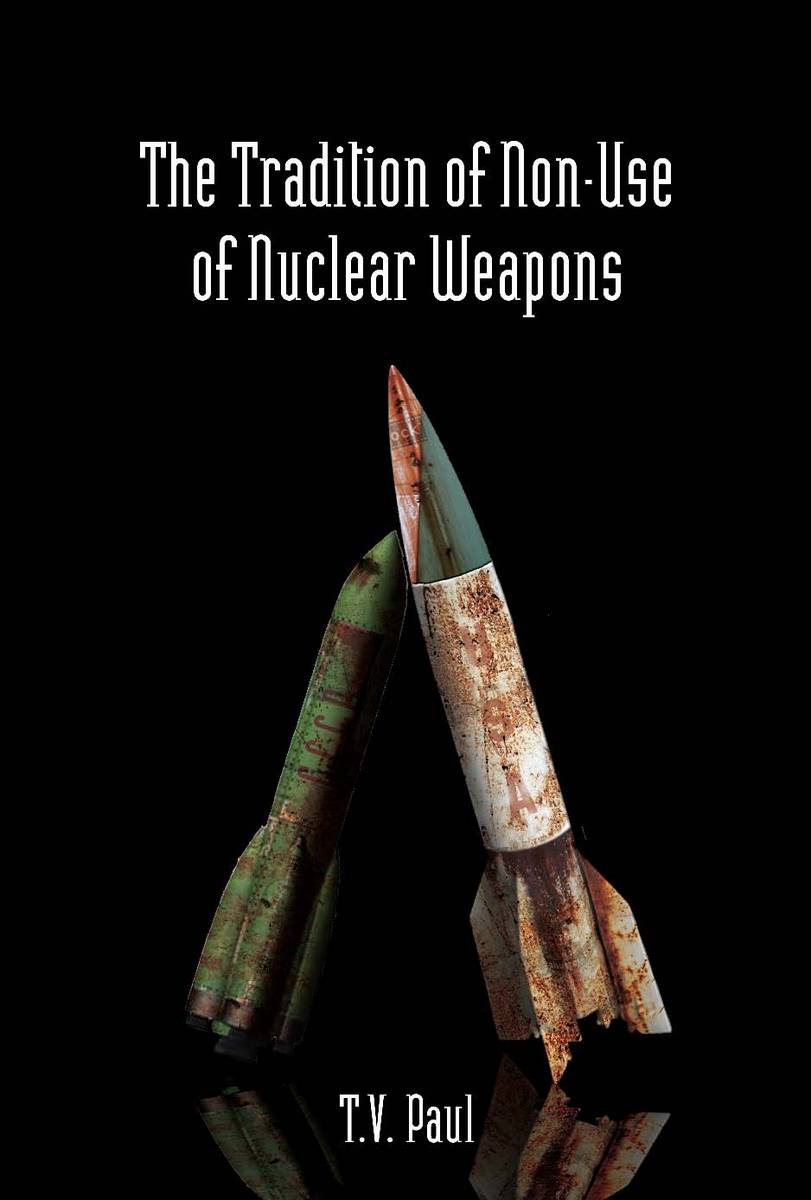
The Tradition of Non-Use of Nuclear Weapons An exploration of the rise, persistence, and impact of the tradition of non-use of nuclear weapons followed by nuclear powers for well over sixty years. POLITICAL SCIENCE,International Relations,Arms Control

Indefensible An essential handbook for all those seeking to debunk the myths that underpin the global arms trade. POLITICAL SCIENCE,International Relations,Arms Control
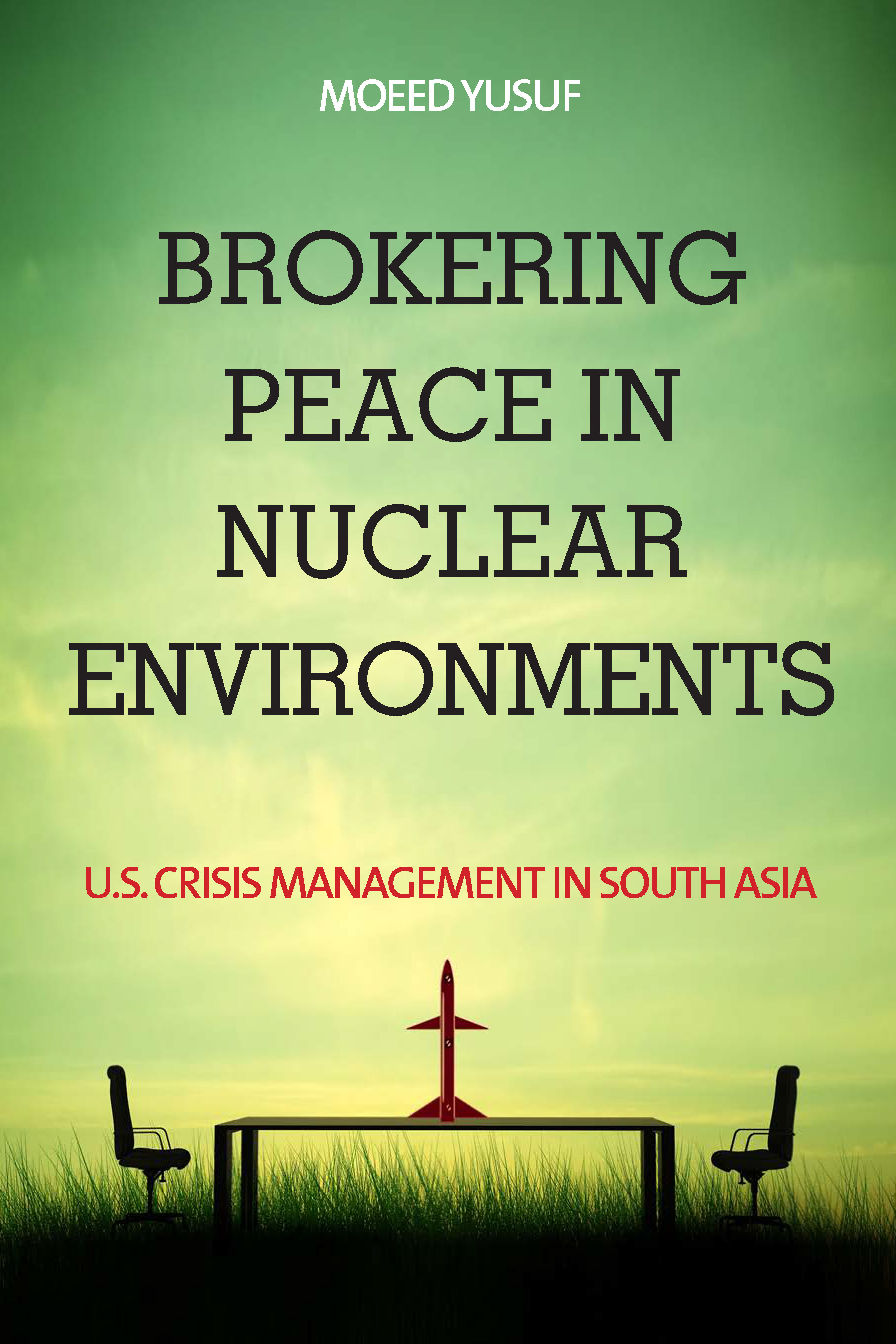
Brokering Peace in Nuclear Environments One of the gravest issues facing the global community today is the threat of nuclear war. As a growing number of nations gain nuclear capabilities, the odds of nuclear conflict increase. Yet nuclear deterrence strategies remain rooted in Cold War models that do not take into account regional conflict. Brokering Peace in Nuclear Environments offers an innovative theory of brokered bargaining to better understand and solve regional crises. As the world has moved away from the binational relationships that defined Cold War conflict while nuclear weapons have continued to proliferate, new types of nuclear threats have arisen. Moeed Yusuf proposes a unique approach to deterrence that takes these changing factors into account. Drawing on the history of conflict between India and Pakistan, Yusuf describes the potential for third-party intervention to avert nuclear war. This book lays out the ways regional powers behave and maneuver in response to the pressures of strong global powers. Moving beyond debates surrounding the widely accepted rational deterrence model, Yusuf offers an original perspective rooted in thoughtful analysis of recent regional nuclear conflicts. With depth and insight, Brokering Peace in Nuclear Environments urges the international community to rethink its approach to nuclear deterrence. POLITICAL SCIENCE,International Relations,Arms Control

Turkey's Nuclear Future Turkey, with a robust modern economy and growing energy needs, is pursuing a switch to nuclear power. But that shift is occurring in an environment fraught with security challenges: Turkey borders Iraq, Syria, and Iranall states with nuclear or WMD ambitions or capabilities. As a NATO member, Turkey also hosts U.S. nuclear bombs on its territory, although some question the durability of this relationship. This dynamic has naturally led to speculation that Turkish leaders might someday consider moving beyond a civilian course to develop nuclear weapons. Yet there has been remarkably little informed analysis and debate on Turkey's nuclear future, either within the country or in broader international society. This volume explores the current status and trajectory of Turkey's nuclear program, adding historical perspective, analytical rigor, and strategic insight. POLITICAL SCIENCE,International Relations,Arms Control
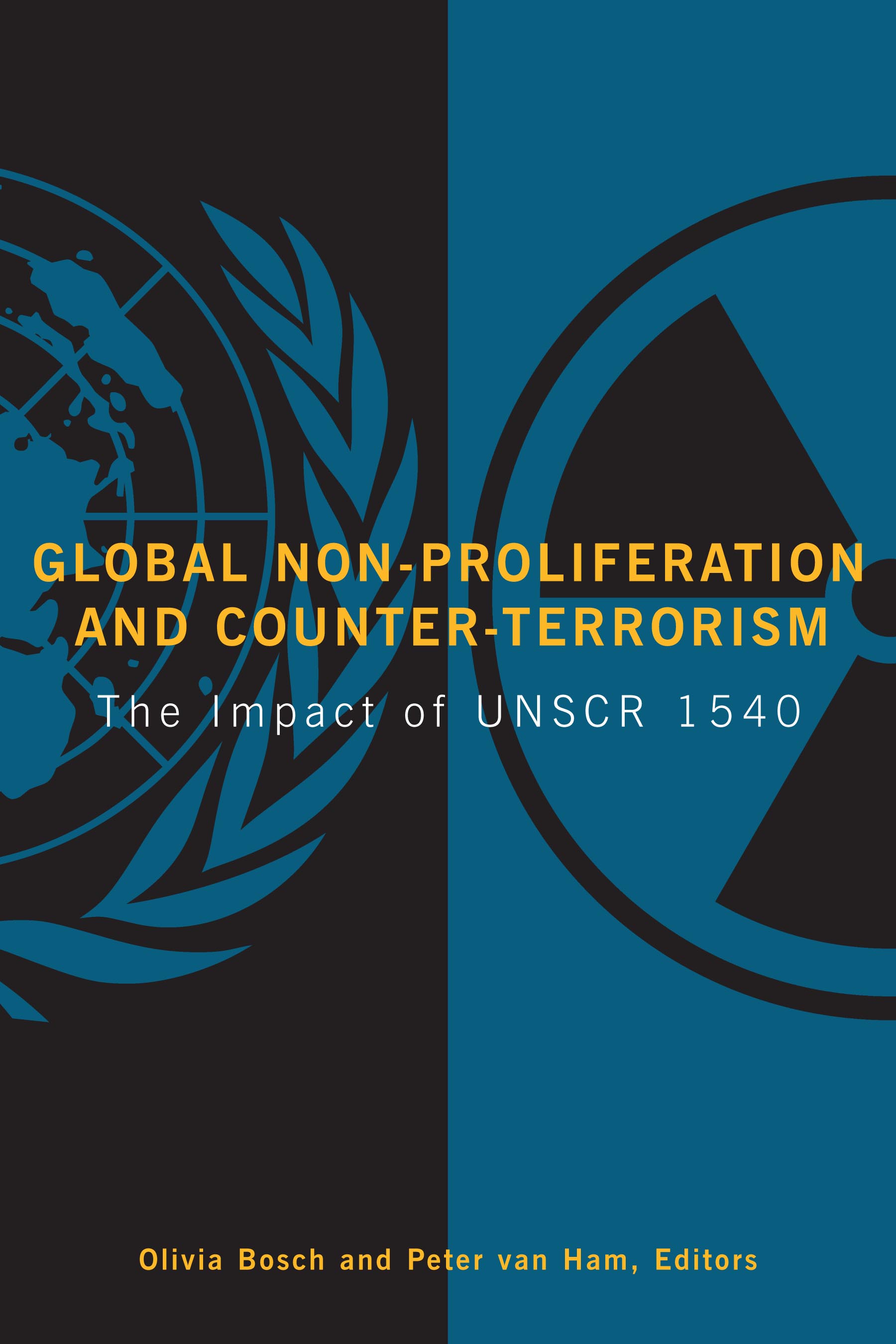
Global Non-Proliferation and Counter-Terrorism A Brookings Institution Press, Chatham House, and Clingendael Institute publication Adopted in April 2004, UN Security Council Resolution 1540 obliges all states to take steps to prevent non-state actors, especially terrorist organizations and arms traffickers, from acquiring weapons of mass destruction and related materials. The United Nations placed itself firmly in the center of one of the world's key international security challenges. Global Non-Proliferation and Counter-Terrorism brings together renowned scholars and policymakers to examine a wide range of new policy-related questions arising from the resolution's impact on the bio-scientific community, the Chemical Weapons Convention, the IAEA, trade and customs, and counter-proliferation initiatives such as the Proliferation Security Initiative (PSI). The impact of 1540 goes beyond setting new legal requirements. It focuses on enforcement not only nationally but also internationally, pressing all states to place their own houses in order. Among the key questions is how the resolution will change the existing network of non-proliferation regimes. Will it merely reinforce requirements of the existing non-proliferation treaties? Or will it offer a legal framework for counter-proliferation activities and other measures to enforce the non-proliferation network? This book provides an overview of the novel policy questions UNSCR 1540's future implementation and enforcement will offer for years to come. Contributors include Jeffrey Almond, Thomas J. Biersteker (Brown University), Olivia Bosch (Chatham House), Gerald Epstein (CSIS), Chandré Gould (Center for Conflict Resolution, Cape Town )], Ron Manley (former OPCW Director of Verification) Sarah Meek (ISS), Siew Gay Ong (Ministry of Foreign Affairs, Singapore), Elizabeth Prescott (AAAS Congressional Fellow), Tariq Rauf (IAEA), Will Robinson (World Customs Organization), Roelof Jan Manschot (Eurojust), Peter van Ham (Netherlands Institute of International Relations), Ted Whiteside (NATO), and Angela Woodward (VERTIC). POLITICAL SCIENCE,International Relations,Arms Control

The Nuclear Tipping Point More than half a century after the advent of the nuclear age, is the world approaching a tipping point that will unleash an epidemic of nuclear proliferation? Today many of the building blocks of a nuclear arsenalscientific and engineering expertise, precision machine tools, software, design informationare more readily available than ever before. The nuclear pretensions of so-called rogue states and terrorist organizations are much discussed. But how firm is the resolve of those countries that historically have chosen to forswear nuclear weapons? A combination of changes in the international environment could set off a domino effect, with countries scrambling to develop nuclear weapons so as not to be left behindor to develop nuclear "hedge" capacities that would allow them to build nuclear arsenals relatively quickly, if necessary. Th e Nuclear Tipping Point examines the factors, both domestic and transnational, that shape nuclear policy. The authors, distinguished scholars and foreign policy practitioners with extensive government experience, develop a framework for understanding why certain countries may originally have decided to renounce nuclear weaponsand pinpoint some more recent country-specific factors that could give them cause to reconsider. Case studies of eight long-term stalwarts of the nonproliferation regimeEgypt, Germany, Japan, Saudi Arabia, South Korea, Syria, Turkey, and Taiwanflesh out this framework and show how even these countries might be pushed over the edge of a nuclear tipping point. The authors offer prescriptions that would both prevent such countries from reconsidering their nuclear option and avert proliferation by others. The stakes are enormous and success is far from assured. To keep the tipping point beyond reach, the authors argue, the international community will have to act with unity, imagination, and strength, and Washington's leadership will be essential. Contributors include Leon Feurth, George Wash POLITICAL SCIENCE,International Relations,Arms Control
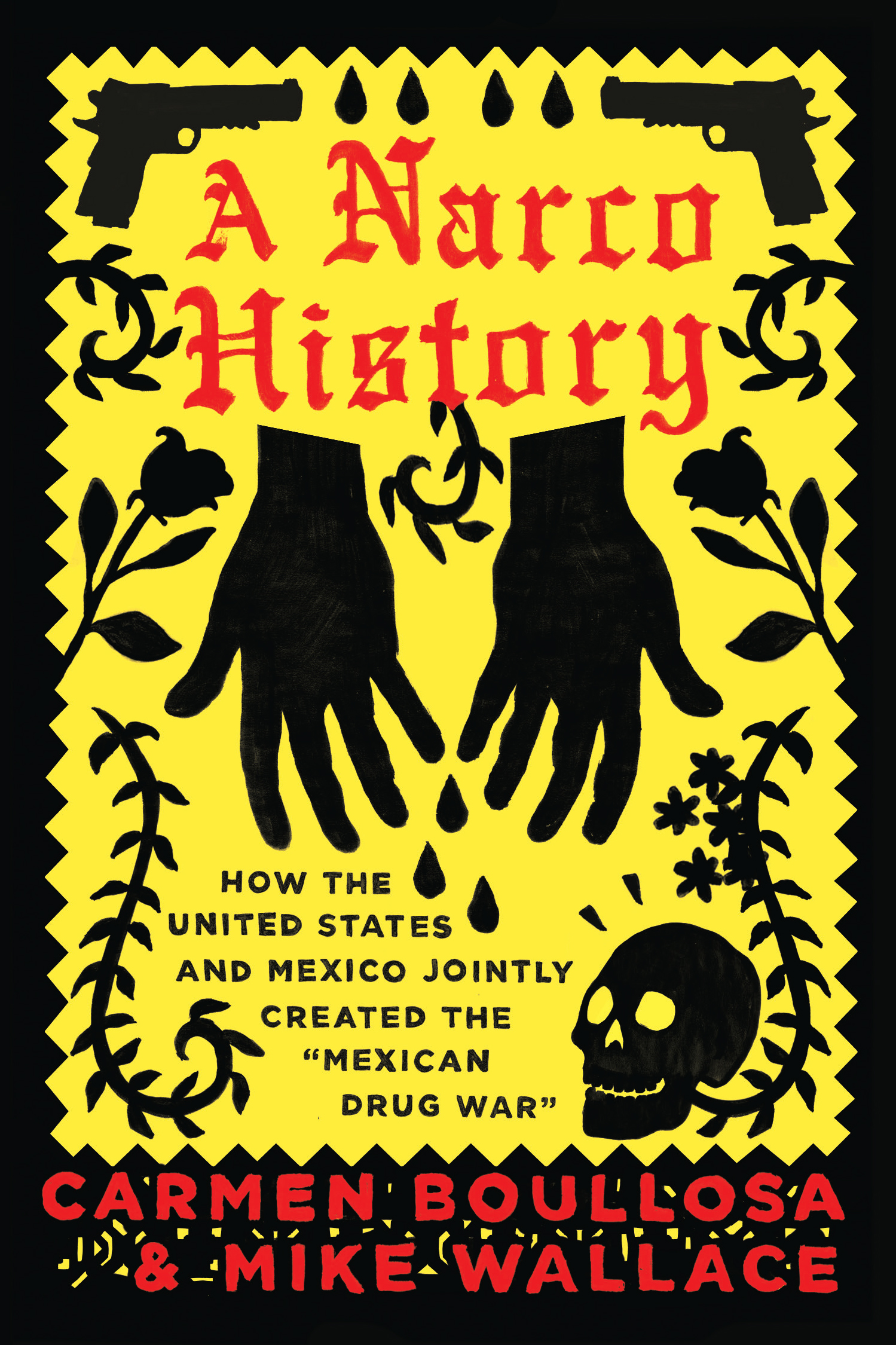
A Narco History The term Mexican Drug War†misleads. It implies that the ongoing bloodbath, which has now killed well over 100,000 people, is an internal Mexican affair. But this diverts attention from the U.S. role in creating and sustaining the carnage. It’s not just that Americans buy drugs from, and sell weapons to, Mexico’s murderous cartels. It’s that ever since the U.S. prohibited the use and sale of drugs in the early 1900s, it has pressured Mexico into acting as its border enforcerwith increasingly deadly consequences.Mexico was not a helpless victim. Powerful forces within the country profited hugely from supplying Americans with what their government forbade them. But the policies that spawned the drug war have proved disastrous for both countries. Written by two award-winning authors, one American and the other Mexican, A Narco History reviews the interlocking twentieth-century histories that produced this twenty-first century calamity, and proposes how to end it. POLITICAL SCIENCE,International Relations,Arms Control

Unending Crisis In Unending Crisis, Thomas Graham Jr. examines the second Bush administration's misguided management of foreign policy, the legacy of which has been seven major--and almost irresolvable--national security crises involving North Korea, Iran, Afghanistan, Pakistan, Iraq, the Arab-Israeli conflict in Palestine, and nuclear proliferation. Unending Crisis considers these issues individually and together, emphasizing their interrelationship and delineating the role that the neoconservative agenda played in redefining the way America is perceived in the world today. POLITICAL SCIENCE,International Relations,Arms Control

A Survey of Chemical and Biological Warfare An in-depth analysis of nearly all chemical and biological weapons, their effects, and the politics surrounding their deployment. POLITICAL SCIENCE,International Relations,Arms Control
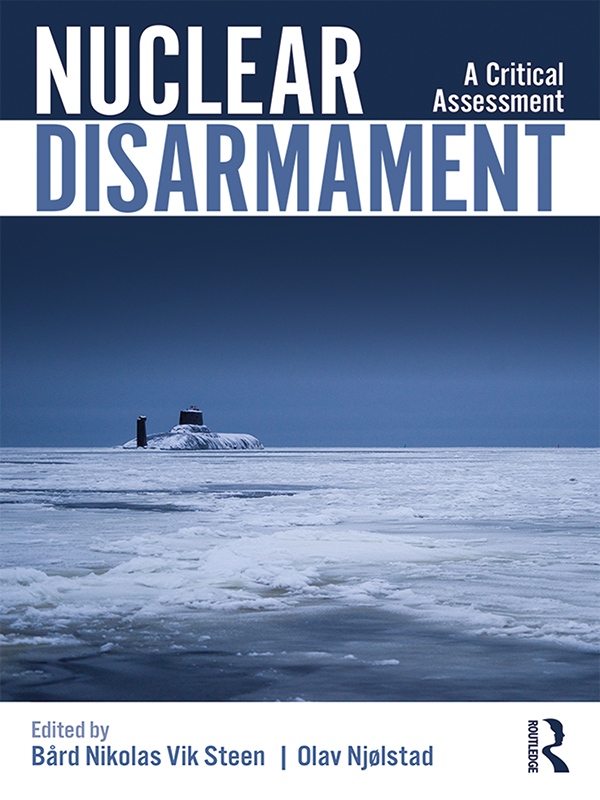
Nuclear Disarmament This volume, Nuclear Disarmament, provides a comprehensive overview of nuclear disarmament and a critical assessment of the way forward. Comprising essays by leading scholars on nuclear disarmament, the book highlights arguments in favour and against a world without nuclear weapons (global zero). In doing so, it proposes a new baseline from which an everchanging nuclear arms control and disarmament agenda can be assessed. Numerous paths to nuclear disarmament have been proposed and scrutinized, and with an increasing number of countries signing off on the Treaty on the Prohibition of Nuclear Weapons, it is vital to ask which path is the most likely and realistic to succeed. The chapters here also address the rapid pace of technological, political and climatic developments, in relation to nuclear disarmament, and how they add to the complexity of the issue. Taking care to unite the different tribes in the debate, this book provides a community of dissent at a time when academic tribalism all too often prevents genuine debates from taking place. This book will be of interest to students of nuclear proliferation, arms control, security studies and International Relations. POLITICAL SCIENCE,International Relations,Arms Control
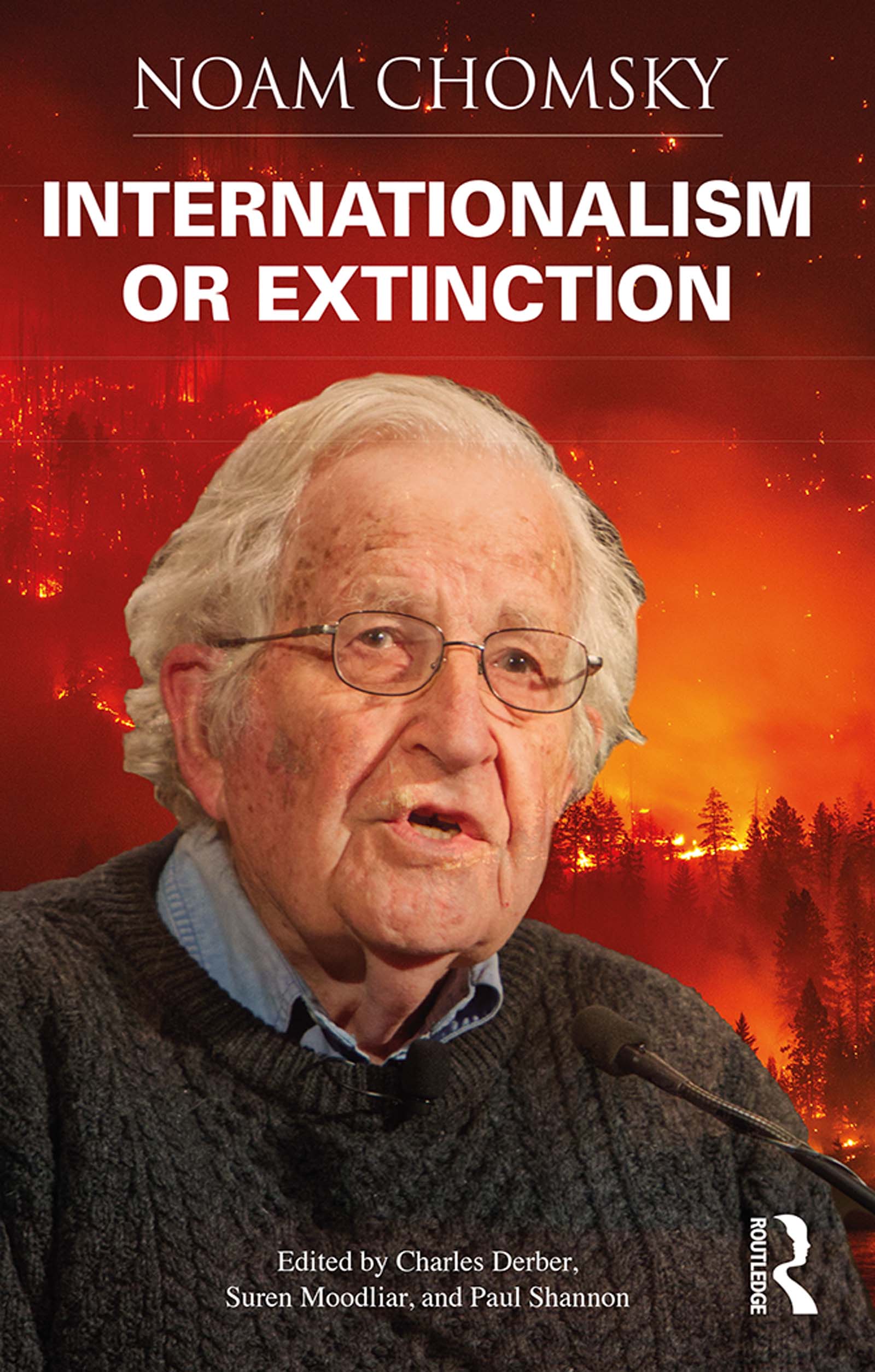
Internationalism or Extinction In his new book, Noam Chomsky writes cogently about the threats to planetary survival that are of growing alarm today. The prospect of human extinction emerged after World War II, the dawn of a new era scientists now term the Anthropocene. Chomsky uniquely traces the duality of existential threats from nuclear weapons and from climate change—including how the concerns emerged and evolved, and how the threats can interact with one another. The introduction and accompanying interviews place these dual threats in a framework of unprecedented corporate global power which has overtaken nation states’ ability to control the future and preserve the planet. Chomsky argues for the urgency of international climate and arms agreements, showing how global popular movements are mobilizing to force governments to meet this unprecedented challenge to civilization’s survival. POLITICAL SCIENCE,International Relations,Arms Control

Guns and Control A Nonpartisan guide that arms both sides of the gun control debate. The slogan of the Gun Facts Project is “We are neither pro-gun nor anti-gun. We are pro-math and anti-BS.†From project creator Guy Smith comes Guns and Control: A Nonpartisan Guide to Mass Public Shootings, Gun Accidents, Crime, Public Carry, Suicides, Defensive Use, and More. No matter what side of the aisle one is on, people are baffled by gun control. This book is designed to be a guide to thoughtful discussion; it arms readers with facts and the logic behind conflicting arguments and leaves emotional rhetoric to the pundits and focuses on the thorny issues of the debate. Guns and Control will: • Guide readers step-wise through each of the major gun control topics: mass public shootings, assault weapons, street crime, suicide, private carry, defensive gun use, gun availability, and more. • Help readers gain the broad perspective and the full set of important, true facts, just in time for the 2020 Presidential Election. • Arm readers against some of the more egregious misinformation. • Support readers in formulating their own conclusions. Guns and Control will grant high-level perspectives—for example, that mass public shootings are a global phenomenon, occurring in nearly all developed nations—and explore details to understand the causes, and thus possible cures, of gun violence-related problems. Was the push for de-institutionalization in mental health management a contributing factor to the rise in mass public shootings? Guns and Control will help readers find answers to such questions. What the public lacks is a clear, unbiased, broad perspective on the realities of guns, explained in simple, straightforward, and entertaining ways. Guns and Control will demystify these misunderstood aspects of who uses and misuses guns. POLITICAL SCIENCE,International Relations,Arms Control
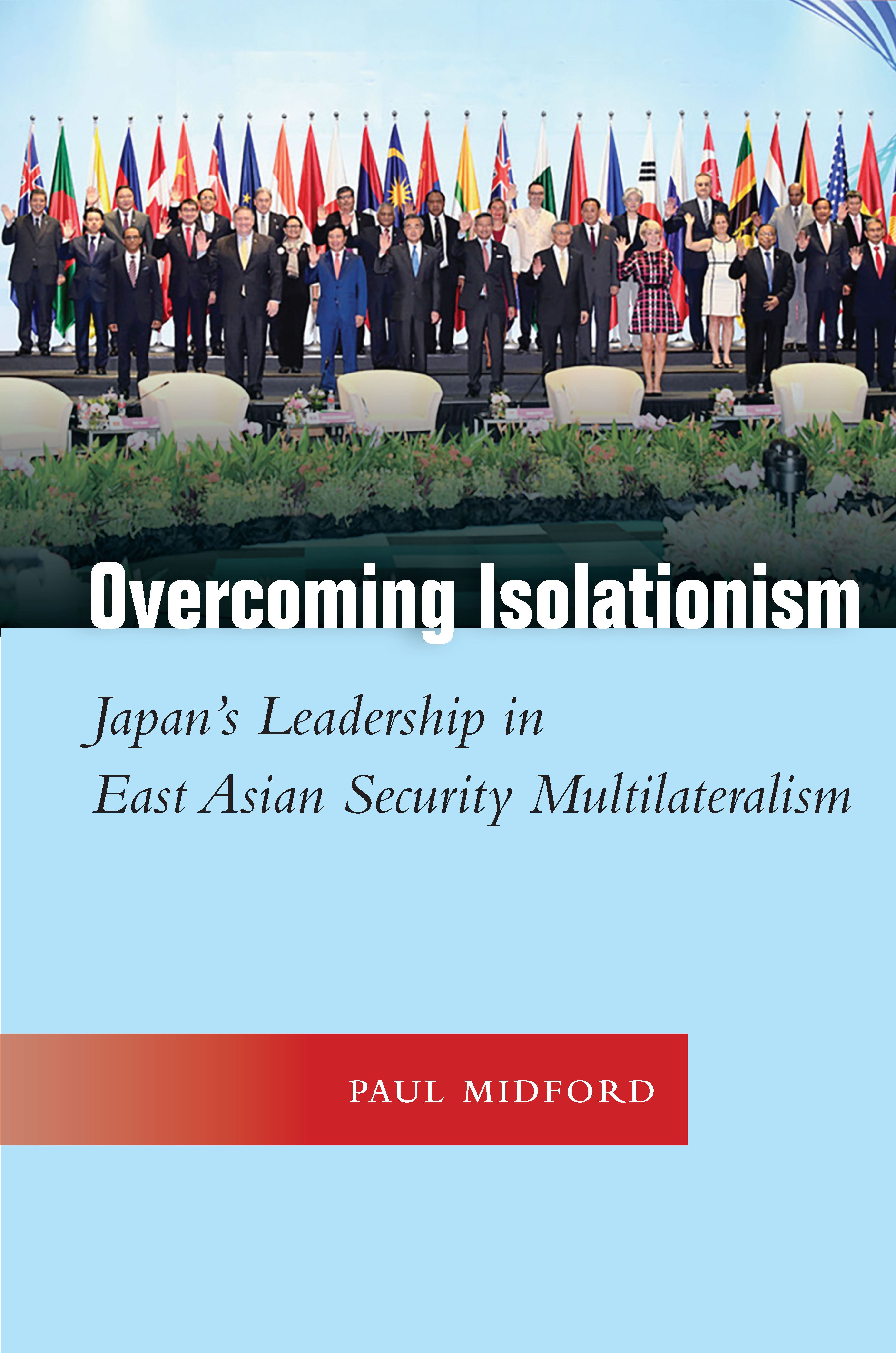
Overcoming Isolationism This book asks why, in the wake of the Cold War, Japan suddenly reversed years of steadfast opposition to security cooperation with its neighbors. Long isolated and opposed to multilateral agreements, Japan proposed East Asia's first multilateral security forum in the early 1990s, emerging as a regional leader. Overcoming Isolationism explores what led to this surprising about-face and offers a corrective to the misperception that Japan's security strategy is reactive to US pressure and unresponsive to its neighbors. Paul Midford draws on newly released official documents and extensive interviews to reveal a quarter century of Japanese leadership in promoting regional security cooperation. He demonstrates that Japan has a much more nuanced relationship with its neighbors and has played a more significant leadership role in shaping East Asian security than has previously been recognized. POLITICAL SCIENCE,International Relations,Arms Control
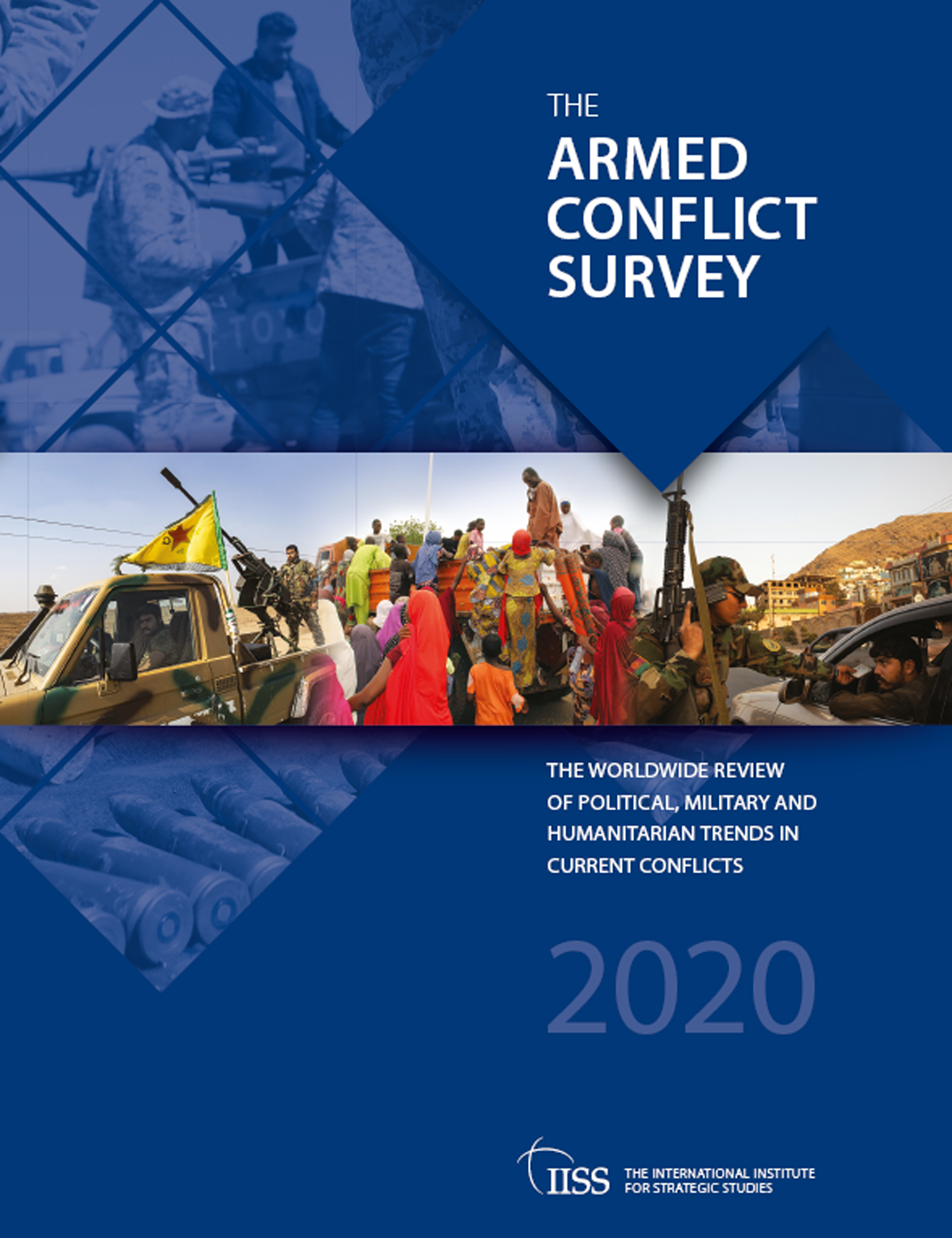
Armed Conflict Survey 2020 The Armed Conflict Survey is the annual review of the political, military and humanitarian dimensions of all active conflicts from the International Institute for Strategic Studies. It offers in-depth analysis of the drivers, dynamics and impact of 33 current wars along with detailed information on conflict parties and more than 60 full-colour maps and infographics. The Armed Conflict Survey is an essential resource for those involved in security policymaking, and an indispensable handbook for anyone conducting serious analysis of armed conflict. Key features · Essays on global trends in armed conflict with a focus on armed groups and their increasingly horizontal structures, adaptability and propensity for exploiting technology. · Overviews of key events and political and military developments in 2019 for each conflict. · In-depth analysis of the underlying drivers and historical roots of conflicts. · Expanded information on conflict parties. · New timelines showing the key political and military developments of 2019. · Analysis of the humanitarian, social and economic impact of conflicts. · Conflict-specific trends, strategic implications and prospects for peace. · More than 60 full-colour maps, tables and infographics highlighting key conflict developments and data. · Key statistics on refugees, internally displaced persons and people in need. · The 2020 Chart of Armed Conflict, providing an overview of conflict actors including state forces, armed groups and multinational missions to conflict and post-conflict countries. POLITICAL SCIENCE,International Relations,Arms Control

Why Nuclear Disarmament Matters From the former UN head weapons inspector in Iraq, a plea for a renewed global disarmament movement. In 2002 Dr. Hans Blix, then chief United Nations weapons inspector, led his team on a search for weapons of mass destruction in Iraq. Before the United States went to war with Iraq the next March, he maintained there were no WMD in Iraq. History proved him right. For more than forty years Dr. Blix has worked on global disarmament, and with this new book he renews the call for nuclear nonproliferation. His interests, though, go beyond stemming the threat of nuclear attack from rogue states and terrorists. It is not, he argues, a recipe for success for nuclear states to tell the rest of the world that it must stay away from the very weapons that nuclear states claim are indispensable. We will never be able to convince rogue states to halt the pursuit of nuclear weapons programs unless we take the lead in a new nonproliferation and disarmament movement. Looking back at the UN post-World War II efforts against the use of nuclear weapons, Blix documents the retreat from early commitments by nuclear powers, most alarmingly from pledges against first use and toward programs to develop new types of nuclear weapons. He urges us to revive these efforts, and that the world's powers also look at issues of global disarmament and security as pieces of the same puzzle. Why Nuclear Disarmament Matters includes specific suggestions—how the UN can set the stage for a credible multilateral disarmament and nonproliferation process; what kind of treaties would be most helpful—and recommendations for regional policy, including providing the Middle East with enriched uranium for civilian nuclear power production but not allowing uranium enrichment there. From March 2000 to June 2003 Hans Blix was Executive Chairman of the UN Monitoring, Verification, and Inspection Commission (UNMOVIC). Dr. Blix, author of Disarming Iraq, is Chair of the Swedish government's Commission on Weapons of Mass Destruction. POLITICAL SCIENCE,International Relations,Arms Control

Arms in Academia This book studies how the arms trade has continued to receive generous state subsidies, along with less direct forms of financial and intellectual support from academia in the UK. It examines the ways in which arms dealing has contributed to the violation of human rights in the Middle East, North Africa, South America, Indochina and other regions of intense conflict, and in doing so, reveals how the industry sells a particular image of itself to the public. The volume: Extensively covers the arms trade and its impact across the world. Shows how the UK arms trade has developed research, investment and consultancy links with universities, museums and other public institutions. Discusses the future of the arms trade and explores alternatives in terms of job opportunities, economic growth and academic research criteria. A major intervention in international politics, this volume will be of great interest to scholars and researchers of military and strategic studies, international relations, human rights and the social sciences in general. It will also be of interest to policy analysts and defence professionals. POLITICAL SCIENCE,International Relations,Arms Control

Russian Military Intelligence in the War with Japan, 1904-05 Examining Russian military intelligence in the war with Japan of 1904-05, this book, based on newly-accessible documents from the tsarist era military, naval and diplomatic archives, gives an overview of the origins, structure and performance of Russian military intelligence in the Far East at the turn of the twentieth century, investigating developments in strategic and tactical military espionage, as well as combat renaissance. It provides a comprehensive reappraisal of the role of military intelligence in the years immediately preceding the First World War, by comparing the Russian military secret services to those of the other great powers, including Britain, Germany, France and Japan. POLITICAL SCIENCE,International Relations,Diplomacy
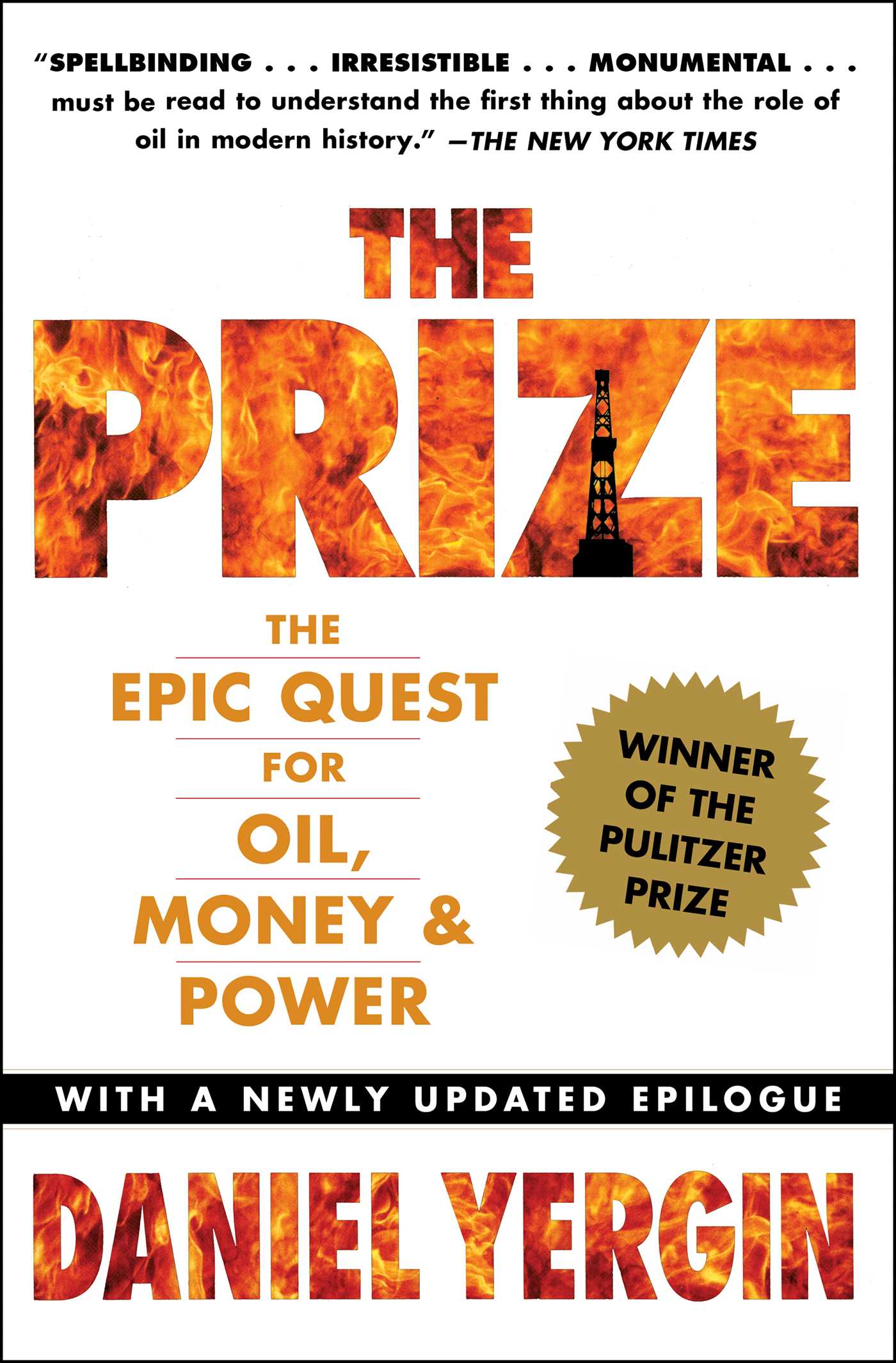
The Prize Deemed "the best history of oil ever written" by Business Week and with more than 300,000 copies in print, Daniel Yergin’s Pulitzer Prize–winning account of the global pursuit of oil, money, and power has been extensively updated to address the current energy crisis. POLITICAL SCIENCE,International Relations,Diplomacy
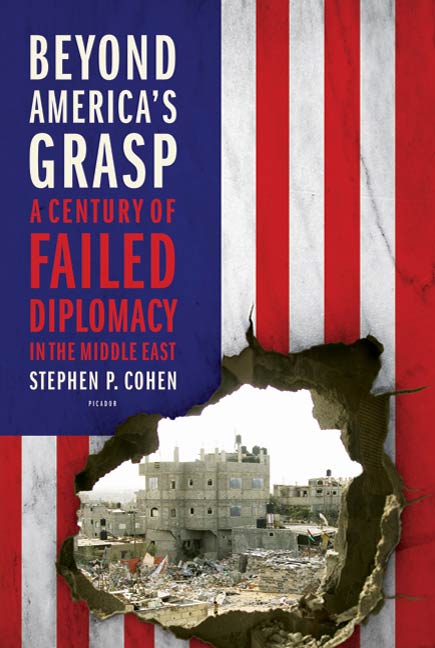
Beyond America's Grasp AN INCISIVE "WHITE PAPER" ON THE UNITED STATES'S STRUGGLE TO FRAME A COHERENT MIDDLE EAST POLICY In this book, the Middle East expert Stephen P. Cohen traces U.S. policy in the region back to the breakup of the Ottoman Empire, when the Great Powers failed to take crucial steps to secure peace there. He sees in that early diplomatic failure a pattern shaping the conflicts since then—and America's role in them. A century ago, there emerged two dominant views regarding the uses of America's newfound power. Woodrow Wilson urged America to promote national freedom and self-determination through the League of Nations—in stark contrast to his predecessor Theodore Roosevelt, who had advocated a vigorous foreign policy based on national self-interest. Cohen argues that this running conflict has hobbled American dealings in the Middle East ever since. In concise, pointed chapters, he shows how different Middle East countries have struggled to define themselves in the face of America's stated idealism and its actual realpolitik. This conflict came to a head in the confused, clumsy Middle East policy of George W. Bush—but Cohen suggests the ways a greater awareness of our history in the region might enable our present leaders to act more sensibly. POLITICAL SCIENCE,International Relations,Diplomacy
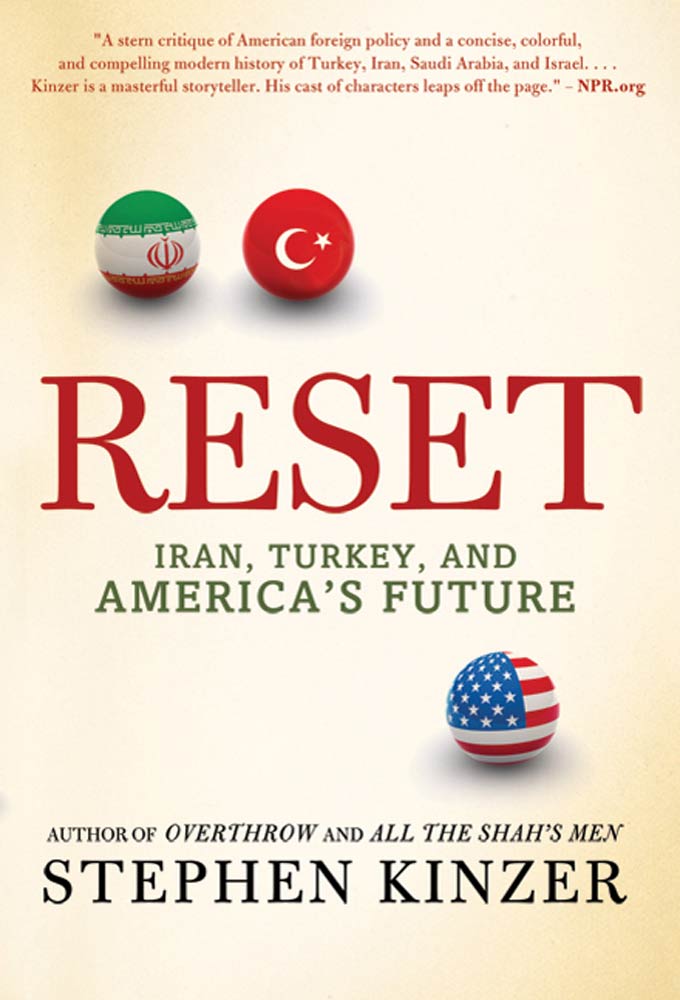
Reset The bestselling author of Overthrow offers a new and surprising vision for rebuilding America's strategic partnerships in the Middle East What can the United States do to help realize its dream of a peaceful, democratic Middle East? Stephen Kinzer offers a surprising answer in this paradigm-shifting book. Two countries in the region, he argues, are America's logical partners in the twenty-first century: Turkey and Iran. Besides proposing this new "power triangle," Kinzer also recommends that the United States reshape relations with its two traditional Middle East allies, Israel and Saudi Arabia. This book provides a penetrating, timely critique of America's approach to the world's most volatile region, and offers a startling alternative. Kinzer is a master storyteller with an eye for grand characters and illuminating historical detail. In this book he introduces us to larger-than-life figures, like a Nebraska schoolteacher who became a martyr to democracy in Iran, a Turkish radical who transformed his country and Islam forever, and a colorful parade of princes, politicians, women of the world, spies, oppressors, liberators, and dreamers. Kinzer's provocative new view of the Middle East is the rare book that will richly entertain while moving a vital policy debate beyond the stale alternatives of the last fifty years. POLITICAL SCIENCE,International Relations,Diplomacy

The Israel Lobby and U.S. Foreign Policy What is the impact of the Israel lobby on U.S. foreign policy—and is it in America's national interest? POLITICAL SCIENCE,International Relations,Diplomacy

34 Days This is the first comprehensive account of the progression of the Second Lebanese War, from the border abduction of an Israeli soldier on the morning of July 12, 2006, through the hasty decision for an aggressive response; the fateful discussions in the Cabinet and the senior Israeli command; to the heavy fighting in south Lebanon and the raging diplomatic battles in Paris, Washington and New York. The book answers the following questions: has Israel learned the right lessons from this failed military confrontation? What can Western countries learn from the IDF's failure against a fundamentalist Islamic terror organization? And what role did Iran and Syria play in this affair? 34 Days delivers the first blow-by-blow account of the Lebanon war and new insights for the future of the region and its effects on the West. POLITICAL SCIENCE,International Relations,Diplomacy
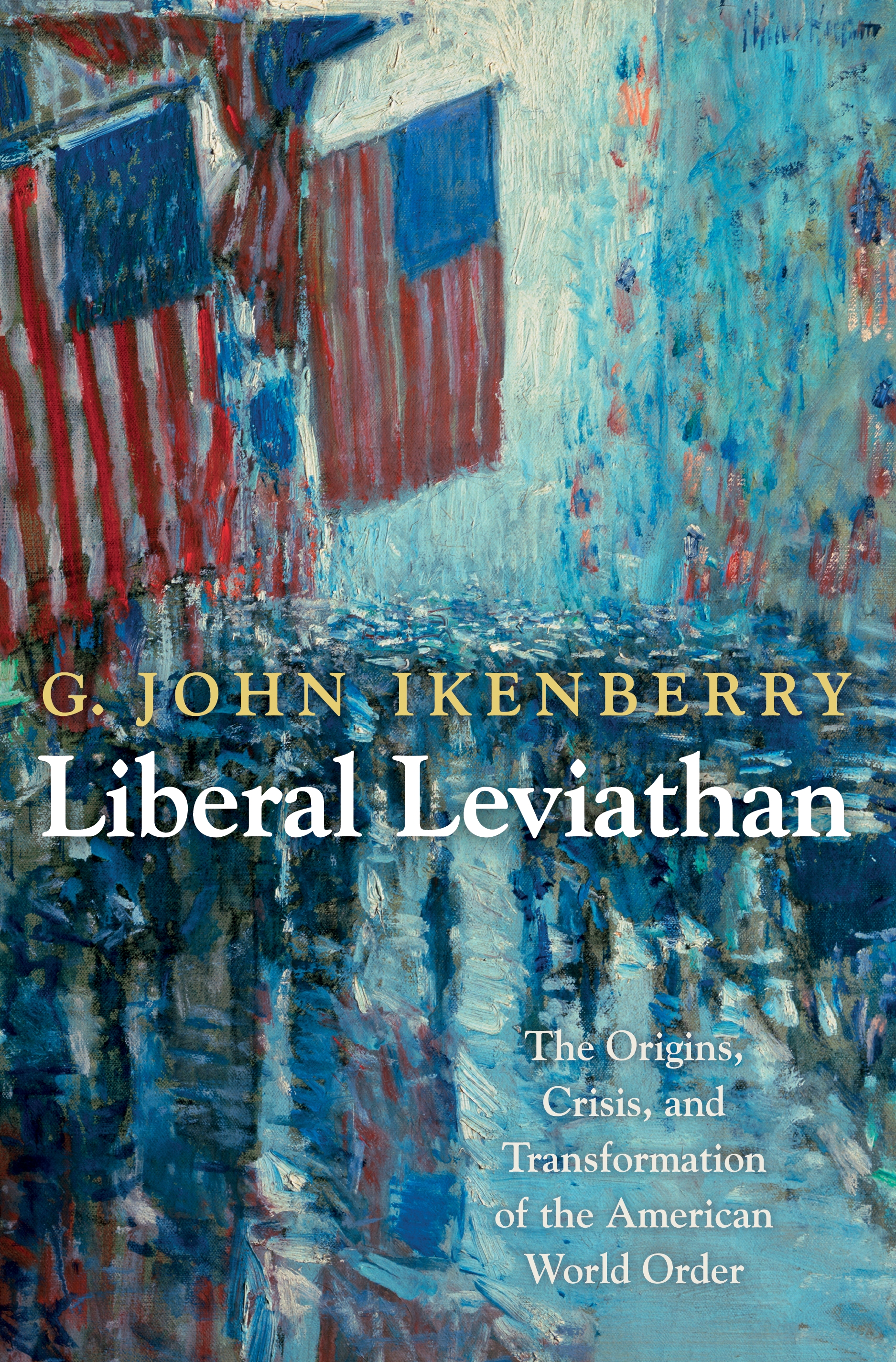
Liberal Leviathan In the second half of the twentieth century, the United States engaged in the most ambitious and far-reaching liberal order building the world had yet seen. This liberal international order has been one of the most successful in history in providing security and prosperity to more people. But in the last decade, the American-led order has been troubled. Some argue that the Bush administration, with its war on terror, invasion of Iraq, and unilateral orientation, undermined this liberal order. Others argue that we are witnessing the end of the American era. Liberal Leviathan engages these debates. G. John Ikenberry argues that the crisis that besets the American-led order is a crisis of authority. A political struggle has been ignited over the distribution of roles, rights, and authority within the liberal international order. But the deeper logic of liberal order remains alive and well. The forces that have triggered this crisis--the rise of non-Western states such as China, contested norms of sovereignty, and the deepening of economic and security interdependence--have resulted from the successful functioning and expansion of the postwar liberal order, not its breakdown. The liberal international order has encountered crises in the past and evolved as a result. It will do so again. Ikenberry provides the most systematic statement yet about the theory and practice of the liberal international order, and a forceful message for policymakers, scholars, and general readers about why America must renegotiate its relationship with the rest of the world and pursue a more enlightened strategy--that of the liberal leviathan. POLITICAL SCIENCE,International Relations,Diplomacy
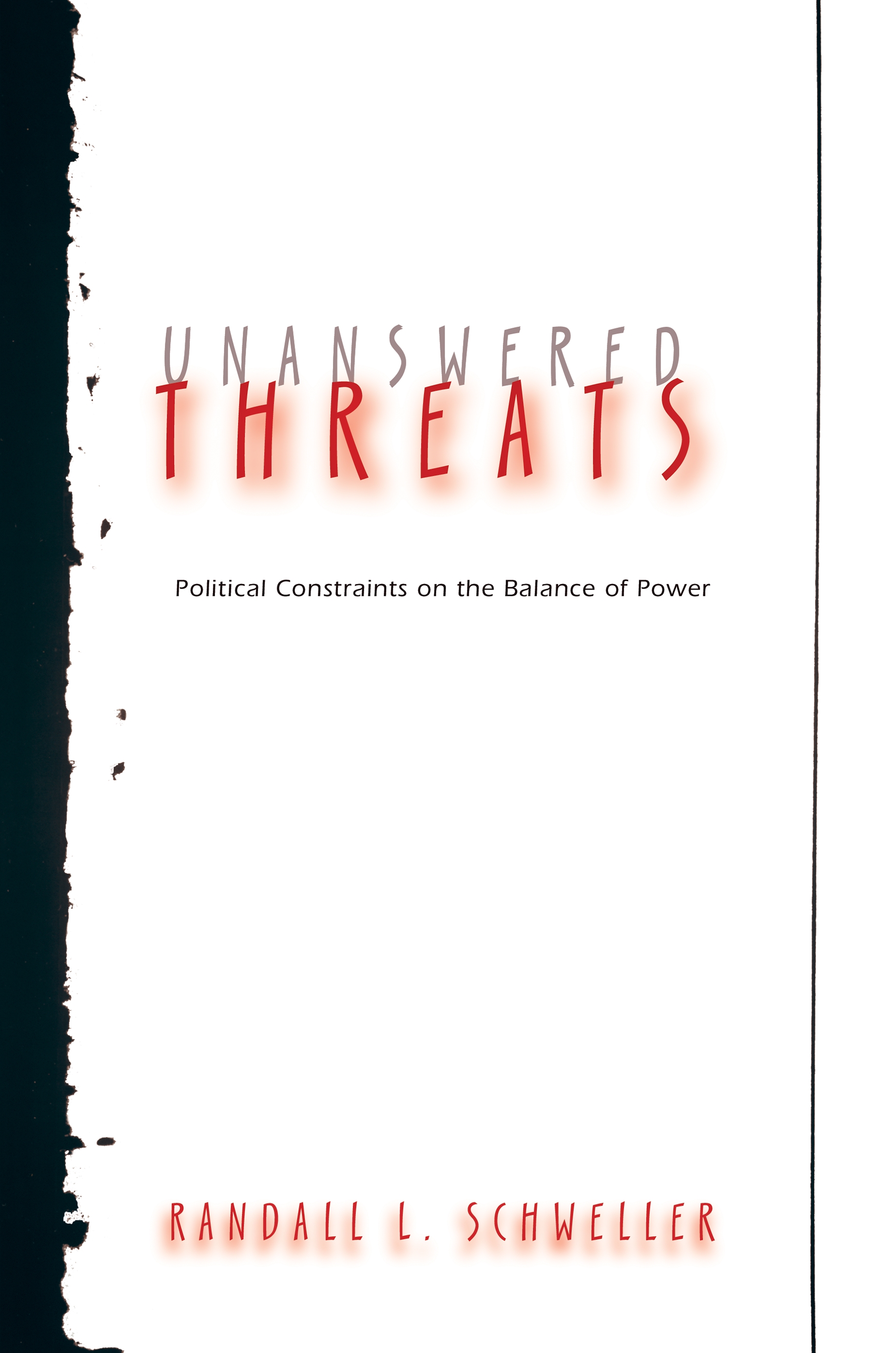
Unanswered Threats Why have states throughout history regularly underestimated dangers to their survival? Why have some states been able to mobilize their material resources effectively to balance against threats, while others have not been able to do so? The phenomenon of "underbalancing" is a common but woefully underexamined behavior in international politics. Underbalancing occurs when states fail to recognize dangerous threats, choose not to react to them, or respond in paltry and imprudent ways. It is a response that directly contradicts the core prediction of structural realism's balance-of-power theory--that states motivated to survive as autonomous entities are coherent actors that, when confronted by dangerous threats, act to restore the disrupted balance by creating alliances or increasing their military capabilities, or, in some cases, a combination of both. Consistent with the new wave of neoclassical realist research, Unanswered Threats offers a theory of underbalancing based on four domestic-level variables--elite consensus, elite cohesion, social cohesion, and regime/government vulnerability--that channel, mediate, and redirect policy responses to external pressures and incentives. The theory yields five causal schemes for underbalancing behavior, which are tested against the cases of interwar Britain and France, France from 1877 to 1913, and the War of the Triple Alliance (1864-1870) that pitted tiny Paraguay against Brazil, Argentina, and Uruguay. Randall Schweller concludes that those most likely to underbalance are incoherent, fragmented states whose elites are constrained by political considerations. POLITICAL SCIENCE,International Relations,Diplomacy

EU Foreign Policymaking and the Middle East Conflict This book examines the interplay between the national and the European levels in EU foreign policymaking, focusing on the Middle East. European engagement in peacemaking in the Middle East dates back to foreign-policy cooperation in the early 1970s. Following the launch of the peace process in 1991, the EU and its Member States further stepped up their involvement in conflict resolution, focusing on one central area of EU engagement – the Israeli-Palestinian conflict. This book covers the period from the beginning of the peace process in 1991 until 2008, and focuses on the actions of the big three Member States: Germany, France and the UK. Using the Europeanization concept as framework of analysis, the book examines the problematic dynamics between these Member States’ national foreign-policy models and the construction of a common European conflict-resolution policy. It also provides interesting new insights into the EU’s international role and potential, addressing the often neglected question of how Europeanization effects help to mitigate some of the classical limitations of European foreign policymaking. The book will be of great interest to students of EU policy, Middle Eastern Politics, peace and conflict resolution, security studies and IR. POLITICAL SCIENCE,International Relations,Diplomacy
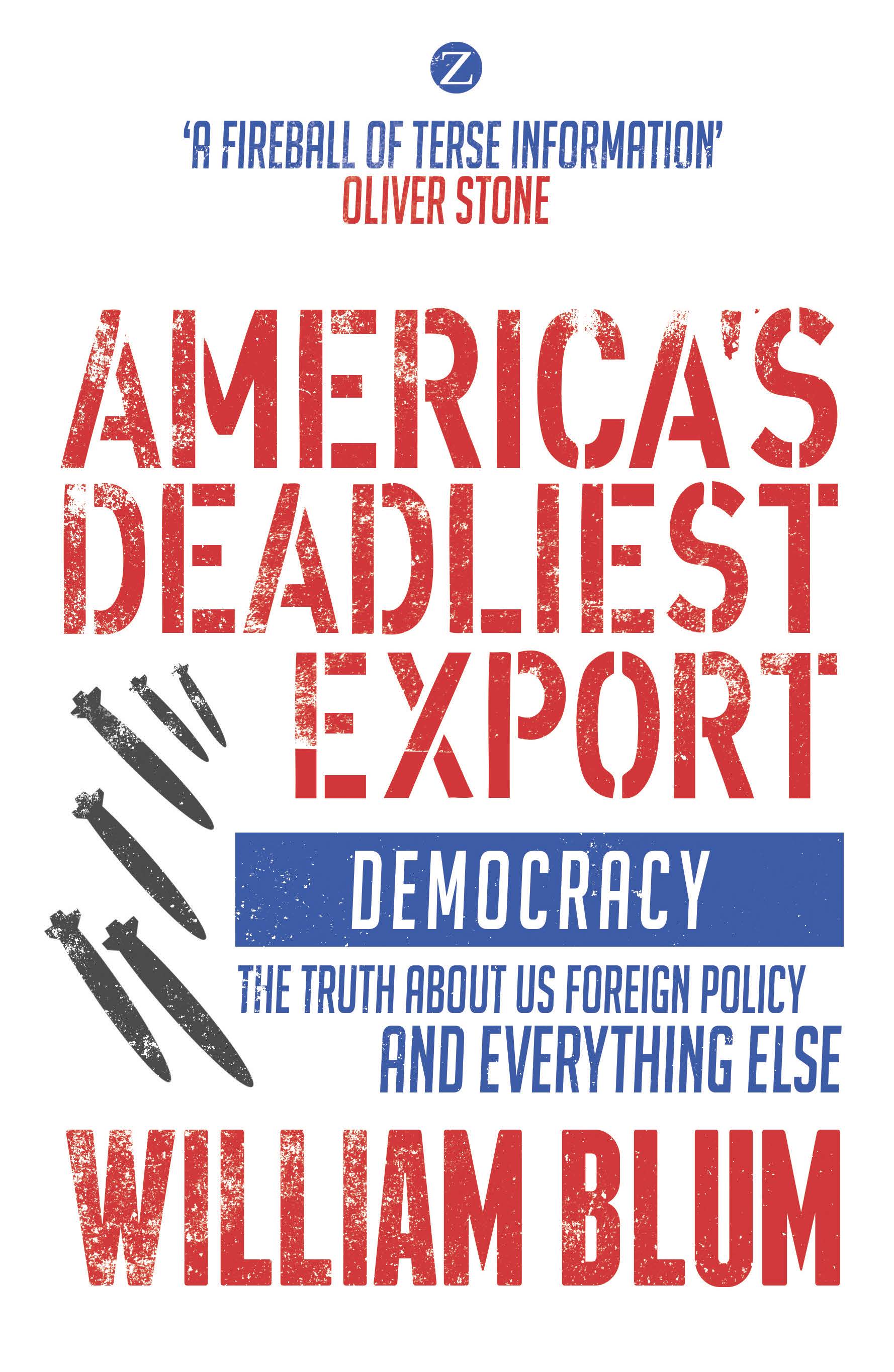
America's Deadliest Export A blistering expose of the hypocrisies and destructive nature of US foreign policy. POLITICAL SCIENCE,International Relations,Diplomacy
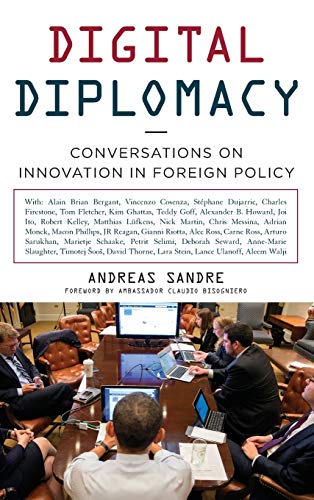
Digital Diplomacy Through conversations with State Department officials, ambassadors, public relations executives, public policy experts, and academics, Digital Diplomacy explores what it means to be innovative in foreign policy and diplomacy. POLITICAL SCIENCE,International Relations,Diplomacy
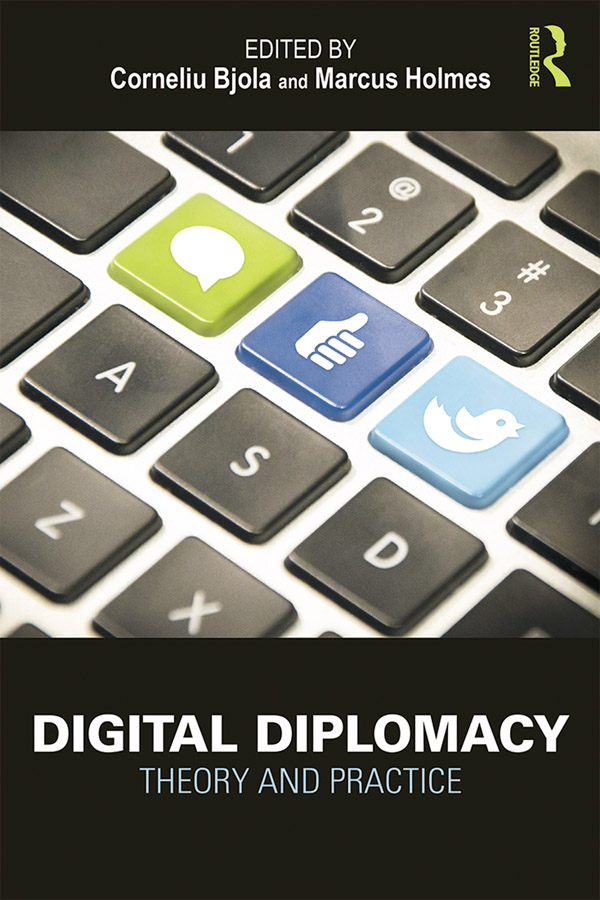
Digital Diplomacy This book analyses digital diplomacy as a form of change management in international politics. The recent spread of digital initiatives in foreign ministries is often argued to be nothing less than a revolution in the practice of diplomacy. In some respects this revolution is long overdue. Digital technology has changed the ways firms conduct business, individuals conduct social relations, and states conduct governance internally, but states are only just realizing its potential to change the ways all aspects of interstate interactions are conducted. In particular, the adoption of digital diplomacy (i.e., the use of social media for diplomatic purposes) has been implicated in changing practices of how diplomats engage in information management, public diplomacy, strategy planning, international negotiations or even crisis management. Despite these significant changes and the promise that digital diplomacy offers, little is known, from an analytical perspective, about how digital diplomacy works. This volume, the first of its kind, brings together established scholars and experienced policy-makers to bridge this analytical gap. The objective of the book is to theorize what digital diplomacy is, assess its relationship to traditional forms of diplomacy, examine the latent power dynamics inherent in digital diplomacy, and assess the conditions under which digital diplomacy informs, regulates, or constrains foreign policy. Organized around a common theme of investigating digital diplomacy as a form of change management in the international system, it combines diverse theoretical, empirical, and policy-oriented chapters centered on international change. This book will be of much interest to students of diplomatic studies, public diplomacy, foreign policy, social media and international relations. POLITICAL SCIENCE,International Relations,Diplomacy

Squandered Opportunity The Islamic Republic of Iran faced a favorable strategic environment following the US invasions of Afghanistan in 2001 and Iraq in 2003. Its leadership attempted to exploit this window of opportunity by assertively seeking to expand Iran's interests throughout the Middle East. It fell far short, however, of fulfilling its long-standing ambition of becoming the dominant power in the Persian Gulf and a leading regional power in the broader Middle East. In Squandered Opportunity, Thomas Juneau develops a variant of neoclassical realism, a theory of foreign policy mistakes, to explore the causes and consequences of Iran's sub-optimal performance. He argues that while rising power drove Iranian assertiveness—as most variants of realism would predict—the peculiar nature of Iran's power and the intervention of specific domestic factors caused Iran's foreign policy to deviate, sometimes significantly, from what would be considered the potential optimal outcomes. Juneau explains that this sub-optimal foreign policy led to important and negative consequences for the country. Despite some gains, Iran failed to maximize its power, its security and its influence in three crucial areas: the Arab-Israeli conflict; Iraq; and the nuclear program. Juneau also predicts that, as the window of opportunity steadily closes for Iran, its power, security, and influence will likely continue to decline in coming years. POLITICAL SCIENCE,International Relations,Diplomacy
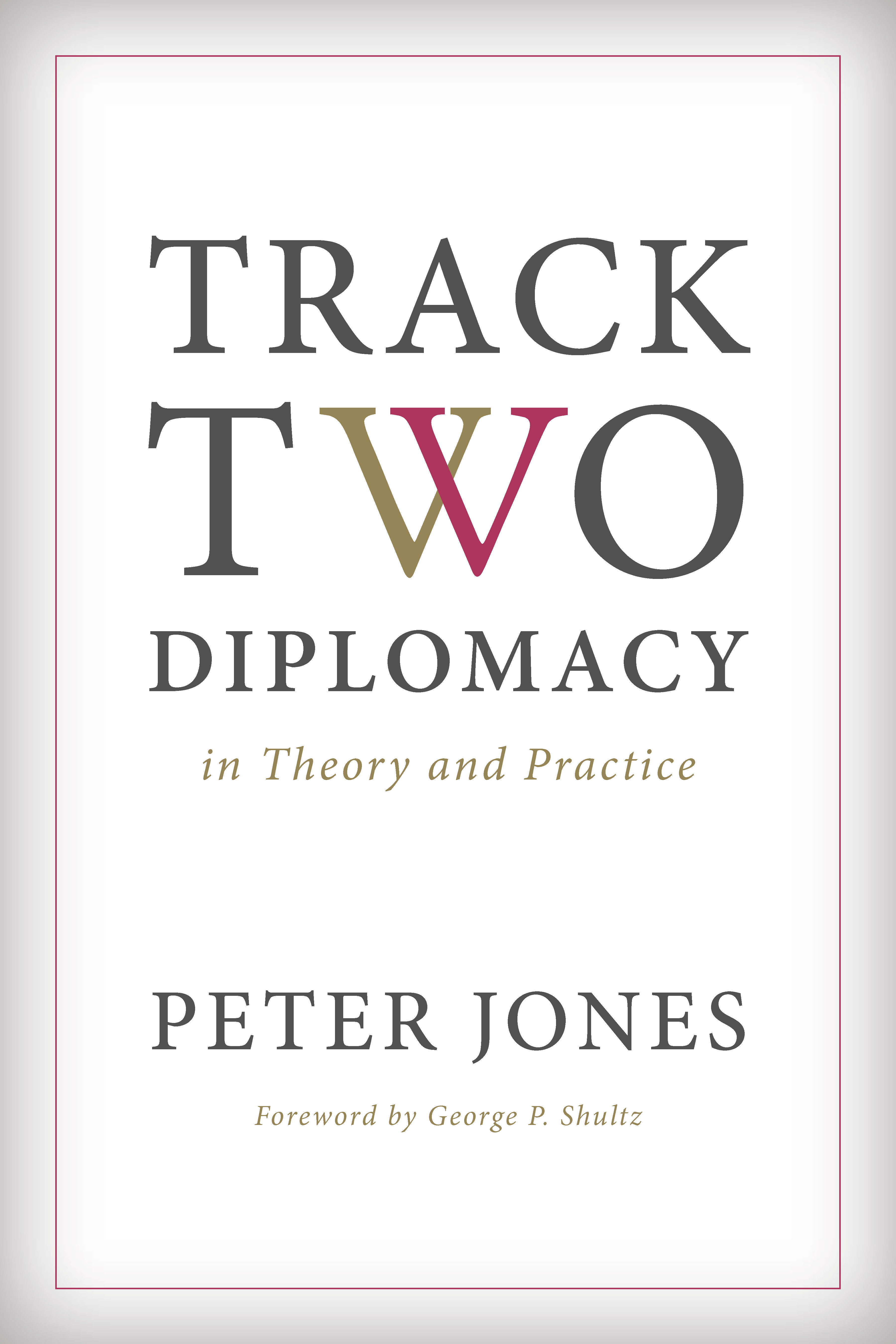
Track Two Diplomacy in Theory and Practice Track Two diplomacy consists of informal dialogues among actors such as academics, religious leaders, retired senior officials, and NGO officials that can bring new ideas and new relationships to the official process of diplomacy. Sadly, those involved in official diplomacy often have little understanding of and appreciation for the complex and nuanced role that Track Two can play, or for its limitations. And many Track Two practitioners are often unaware of the realities and pressures of the policy and diplomatic worlds, and not particularly adept at framing their efforts to make them accessible to hard-pressed officials. At the same time, those interested in the academic study of Track Two sometimes fail to understand the realities faced by either set of practitioners. A need therefore exists for a work to bridge the divides between these constituencies and between the different types of Track Two practice—and this book crosses disciplines and traditions in order to do just that. It explores the various dimensions and guises of Track Two, the theory and practice of how they work, and how both practitioners and academics could more profitably assess Track Two. Overall, it provides a comprehensive picture of the range of activities pursued under this title, to provoke new thinking about how these activities relate to each other, to official diplomacy, and to academe. POLITICAL SCIENCE,International Relations,Diplomacy

The Global Vatican From the centuries-long prejudices against Catholics in America, to the efforts of Fascism, Communism, and modern terrorist organizations to “break the cross and spill the wine,†this book brings to life the Catholic Church’s role in world history, particularly in the realm of diplomacy. The Global Vatican captures the braided nature of religious and political power and the complexities, battles, and future prospects for the relationship between the Holy See and the United States as both face challenges old and new. Updated now to include a view towards Pope Francis’ first trip to the United States, The Global Vatican looks forward to the revitalization of the Church in this newest global papacy. POLITICAL SCIENCE,International Relations,Diplomacy
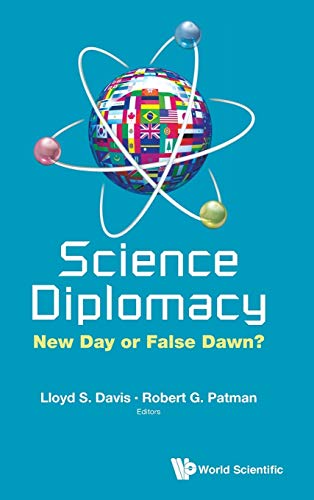
Science Diplomacy As modern foreign policy and international relations encompass more and more scientific issues, we are moving towards a new type of diplomacy, known as “Science Diplomacyâ€. Will this new diplomacy of the 21st century prove to be more effective than past diplomacy for the big issues facing the world, such as climate change, food and water insecurity, diminishing biodiversity, pandemic disease, public health, genomics or environmental collapse, mineral exploitation, health and international scientific endeavours such as those in the space and the Antarctic?Providing a new area of academic focus that has only gathered momentum in the last few years, this book considers these questions by bringing together a distinguished team of international specialists to look at various facets of how diplomacy and science are influenced by each other.The book not only dissects the ways that politics, science and diplomacy have become intertwined, but also highlights how the world's seemingly most intractable problems can be tackled with international collaboration and diplomacy that is rooted in science, and driven by technology. It, therefore, challenges the conventional wisdom concerning the juxtaposition of science and the world of diplomacy. POLITICAL SCIENCE,International Relations,Diplomacy
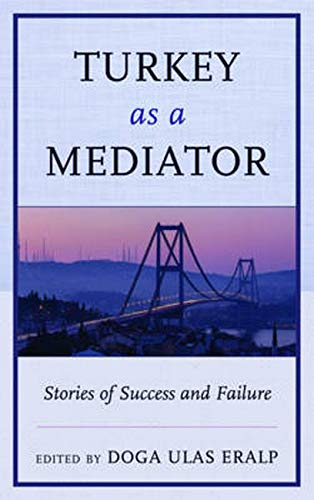
Turkey as a Mediator This book offers a systematic overview of successes and failures of Turkey’s mediation initiatives in fragile and conflict-affected societies in the Middle East, western Balkans, and sub-Saharan Africa. It analyzes the narratives that guide Turkish mediation, the tools used by the Turkish government, and Turkey’s evolving self-image as a mediator. POLITICAL SCIENCE,International Relations,Diplomacy
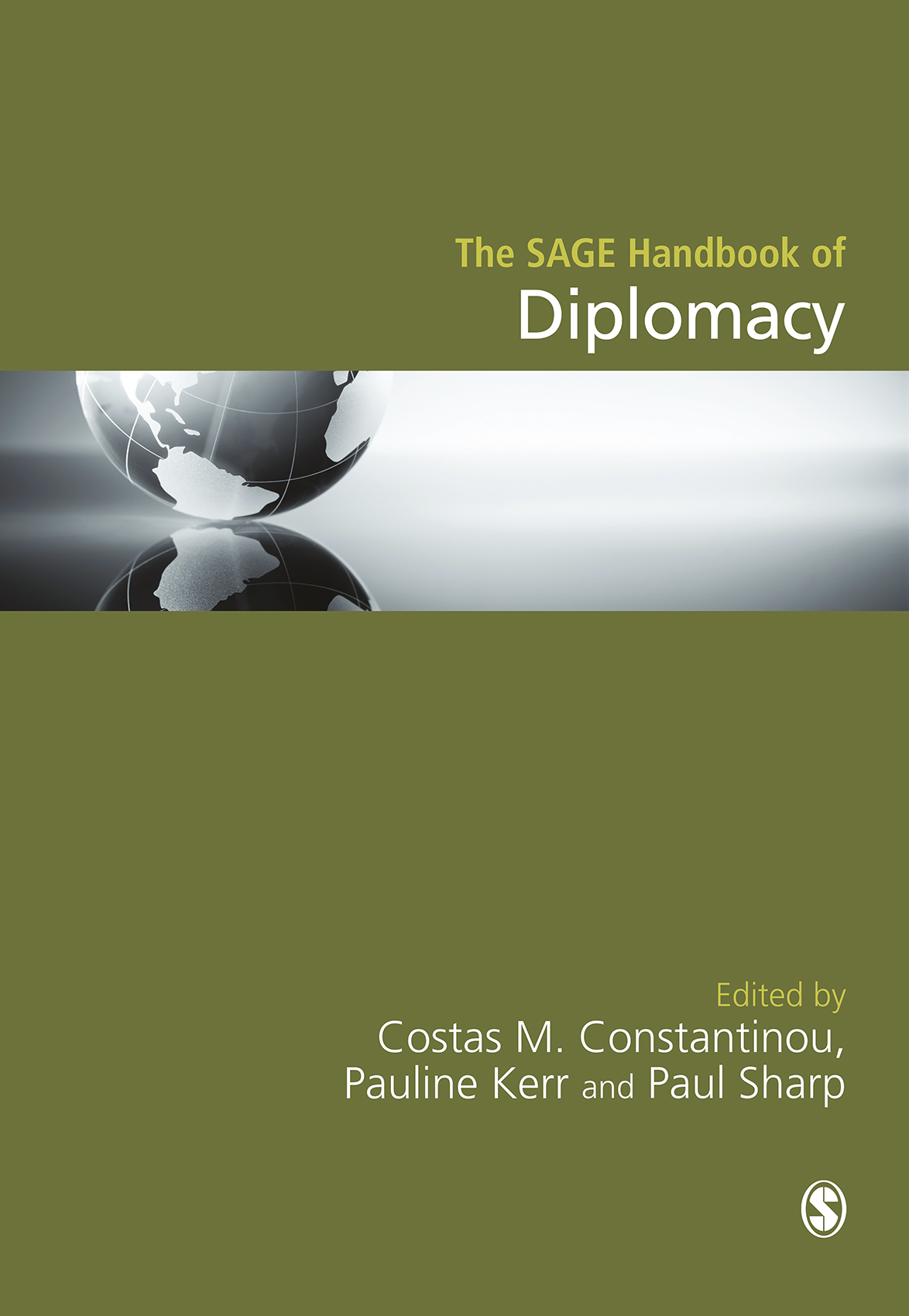
The SAGE Handbook of Diplomacy With broad coverage spanning concepts and theories, institutions, relations, and engagement this new handbook provides state-of-the-art analysis from the world’s leading experts POLITICAL SCIENCE,International Relations,Diplomacy
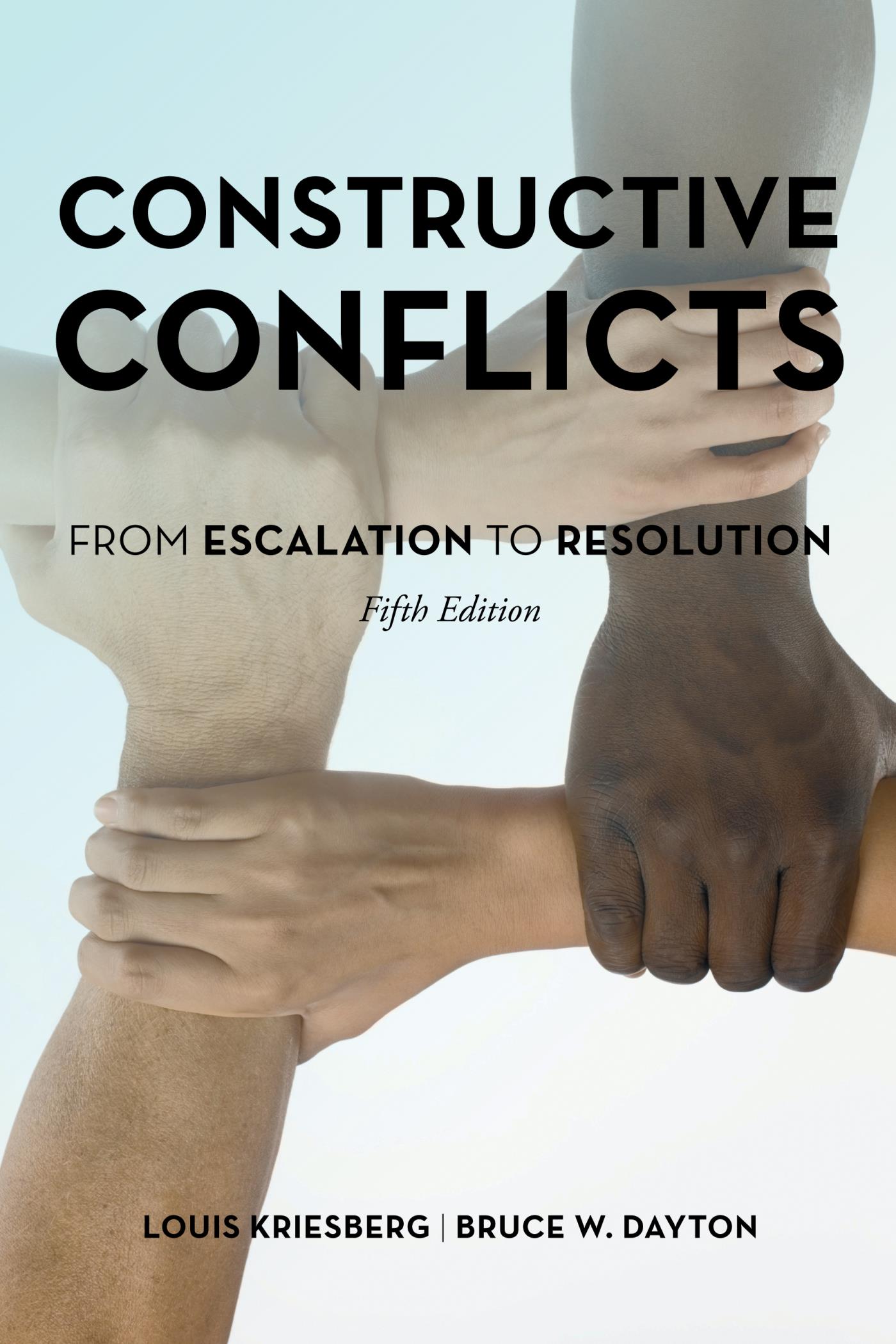
Constructive Conflicts Constructive Conflicts provides a framework for analyzing social conflicts of all kinds, with emphasis on how conflicts can lead to positive change. The fifth edition features new material on the role of social movements and NGOs, non-coercive means for shaping conflict, post-conflict activities that result in enduring peace, and more. POLITICAL SCIENCE,International Relations,Diplomacy
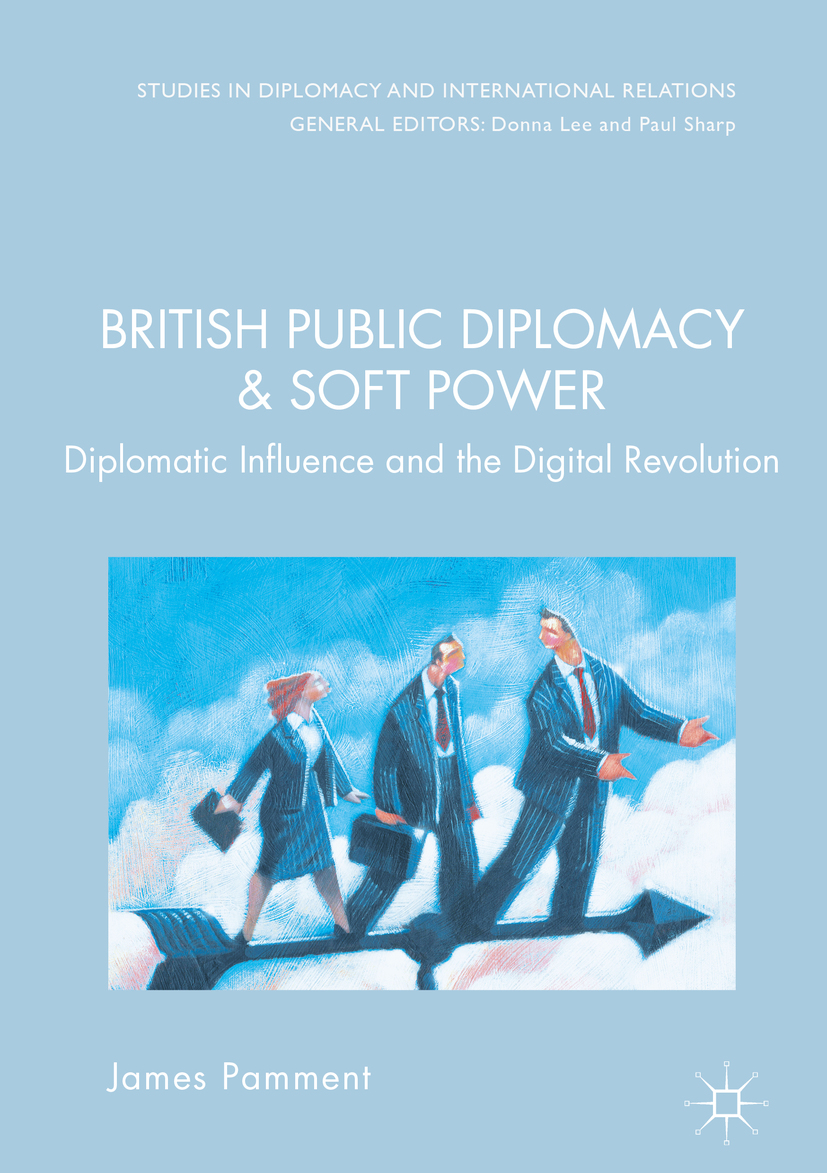
British Public Diplomacy and Soft Power This volume outlines two decades of reforms at the Foreign & Commonwealth Office (FCO), British Council and BBC World Service – the so-called Public Diplomacy Partners. Between 1995 and 2015, the FCO and its partner organisations in promoting British influence abroad have introduced major changes to how, where and with whom diplomacy is conducted. This unique study links major organisational reforms to the changing political, technological and intellectual contexts of the day. Through detailed case studies over a 20-year period, this study demonstrates how and why British diplomacy evolved from a secretive institution to one understanding its purpose as a global thought leader through concepts such as public diplomacy, digital diplomacy and soft power. It is rich with unpublished documents and case studies, and is the most detailed study of the FCO and British Council in the contemporary period. From Cool Britannia to the recent GREAT campaign via the 2012 Olympics and diplomats on Twitter, this book charts the theory and practice behind a 21st century revolution in British diplomacy. This work will be of much interest to policymakers and advisors, students and researchers, and foreign policy and communication specialists. “From the heady past of Cool Britannia to the present days of the Great Campaign by way of the Royal Wedding, London Olympics and multiple other gambits in Britain's evolving attempt to connect to foreign publics, this book is the essential account of the inner workings of a vital aspect of contemporary British foreign policy: public diplomacy. James Pamment is an astute, succinct and engaging Dante, bringing his readers on journey through the policy processes behind the scenes. We see the public diplomacy equivalents of paradise, purgatory and the inferno, though Pamment leaves us to decide which is which.†Nicholas J. Cull, author of ‘The Decline and Fall of the United States Information Agency: American Public Diplomacy, 1989-2001’. “A gift to practitioners who want to do the job better: required reading for anyone going into a senior job at the British Council, the UK Foreign & Commonwealth Office and enlightened thinkers at 10 Downing Street, HM Treasury and Ministries of Foreign Affairs worldwide. Authoritative, scholarly and accurate, Pamment strikes a great balance between the salient details and the overarching picture. He also does a major service to those of us who lived it; our toils make more sense for what he has done - placing them in a historical and conceptual context.†John Worne, Director of Strategy & External Relations, British Council, 2007-2015 POLITICAL SCIENCE,International Relations,Diplomacy

How Statesmen Think Robert Jervis has been a pioneering leader in the study of the psychology of international politics for more than four decades. How Statesmen Think presents his most important ideas on the subject from across his career. This collection of revised and updated essays applies, elaborates, and modifies his pathbreaking work. The result is an indispensable book for students and scholars of international relations. How Statesmen Think demonstrates that expectations and political and psychological needs are the major drivers of perceptions in international politics, as well as in other arenas. Drawing on the increasing attention psychology is paying to emotions, the book discusses how emotional needs help structure beliefs. It also shows how decision-makers use multiple shortcuts to seek and process information when making foreign policy and national security judgments. For example, the desire to conserve cognitive resources can cause decision-makers to look at misleading indicators of military strength, and psychological pressures can lead them to run particularly high risks. The book also looks at how deterrent threats and counterpart promises often fail because they are misperceived. How Statesmen Think examines how these processes play out in many situations that arise in foreign and security policy, including the threat of inadvertent war, the development of domino beliefs, the formation and role of national identities, and conflicts between intelligence organizations and policymakers. POLITICAL SCIENCE,International Relations,Diplomacy
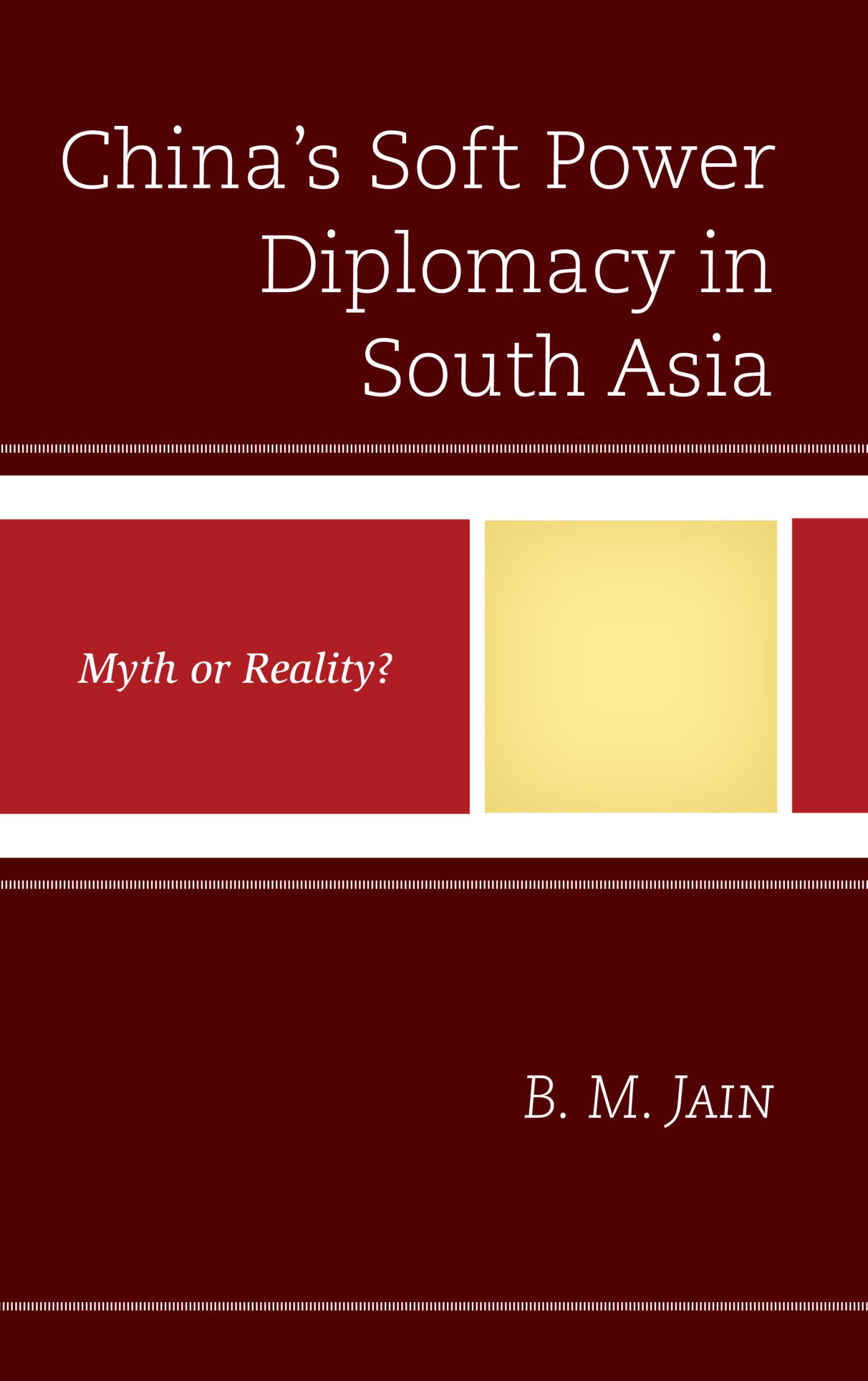
China's Soft Power Diplomacy in South Asia This book examines the Chinese version of soft power and explores its myriad implications for India and all of South Asia. It traces the origin of China’s engagement with South Asian states from historical, political, economic, and security perspectives in order to better understand the dynamics of its South Asia policy. POLITICAL SCIENCE,International Relations,Diplomacy
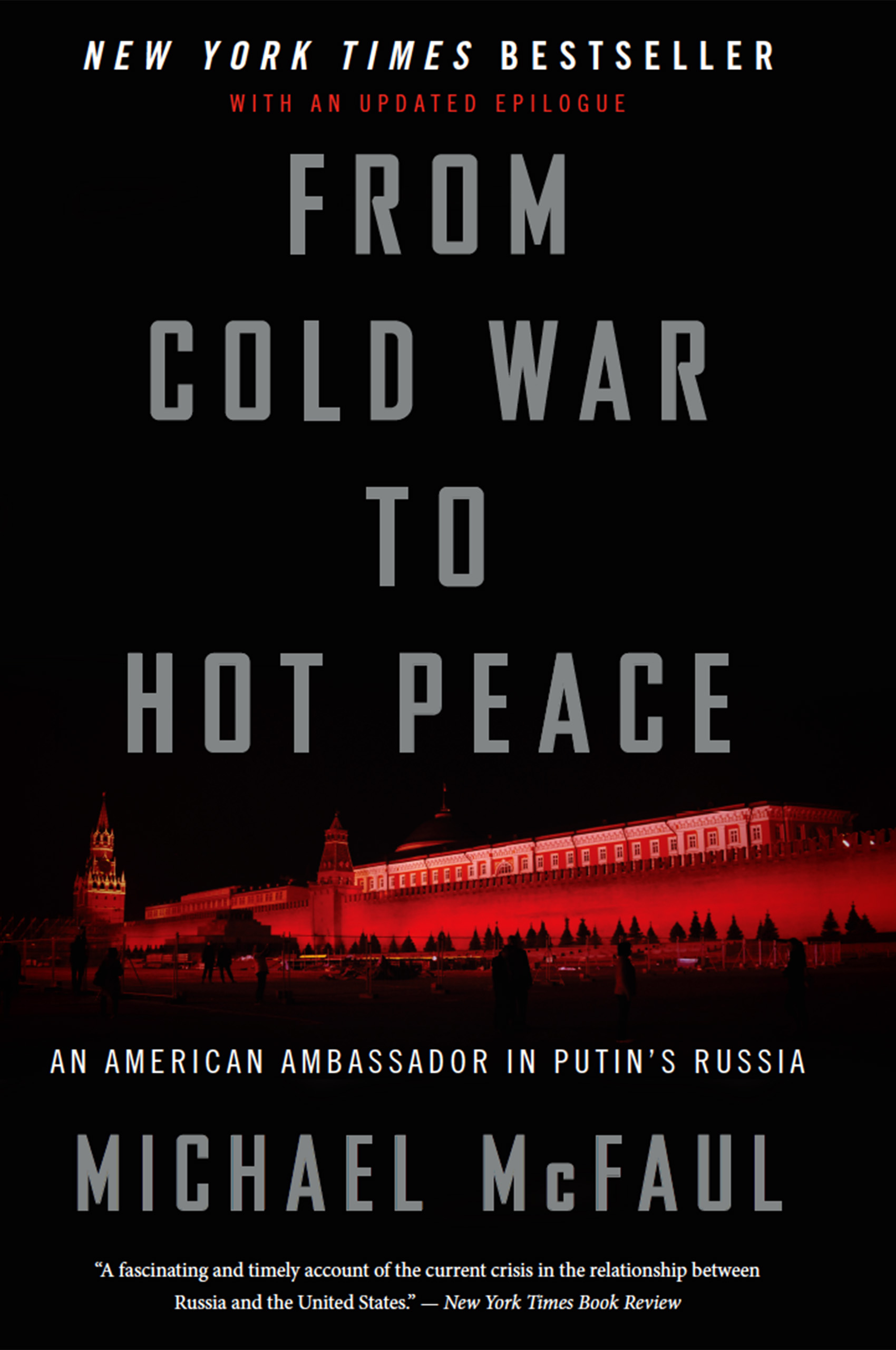
From Cold War to Hot Peace From the Stanford Kremlinologist who served as U.S. ambassador to Russia from 2012 to 2014, and has since been sanctioned by Vladimir Putin, comes a revelatory account of U.S.–Russia relations from 1989 to the present, told through his experience working for President Barack Obama and witnessing the tightening of Putin’s grip firsthand. POLITICAL SCIENCE,International Relations,Diplomacy

The Perfect Weapon NOW AN HBO® DOCUMENTARY FROM AWARD-WINNING DIRECTOR JOHN MAGGIO • “An important—and deeply sobering—new book about cyberwarfare” (Nicholas Kristof, New York Times), now updated with a new chapter. The Perfect Weapon is the startling inside story of how the rise of cyberweapons transformed geopolitics like nothing since the invention of the atomic bomb. Cheap to acquire, easy to deny, and usable for a variety of malicious purposes, cyber is now the weapon of choice for democracies, dictators, and terrorists. Two presidents—Bush and Obama—drew first blood with Operation Olympic Games, which used malicious code to blow up Iran’s nuclear centrifuges, and yet America proved remarkably unprepared when its own weapons were stolen from its arsenal and, during President Trump’s first year, turned back on the United States and its allies. And if Obama would begin his presidency by helping to launch the new era of cyberwar, he would end it struggling unsuccessfully to defend against Russia’s broad attack on the 2016 US election. Moving from the White House Situation Room to the dens of Chinese government hackers to the boardrooms of Silicon Valley, New York Times national security correspondent David Sanger reveals a world coming face-to-face with the perils of technological revolution, where everyone is a target. “Timely and bracing . . . With the deep knowledge and bright clarity that have long characterized his work, Sanger recounts the cunning and dangerous development of cyberspace into the global battlefield of the 21st century.” —Washington Post POLITICAL SCIENCE,International Relations,Diplomacy

Protocol President Obama’s former United States chief of protocol looks at why diplomacy and etiquette matter—from the international stage to everyday life. History often appears to consist of big gestures and dramatic shifts. But for every peace treaty signed, someone set the stage, using hidden influence to effect the outcome. In her roles as chief of protocol for President Barack Obama and social secretary to President Bill Clinton and First Lady Hillary Clinton, Capricia Penavic Marshall not only bore witness to history, she facilitated it. From arranging a room to have an intended impact on the participants to knowing which cultural gestures earned trust, her behind-the scenes preparations laid the groundwork for successful diplomacy between heads of state around the world and tilted the playing field in her team's favor. If there's one thing that working at the highest levels of government for over two decades has taught Marshall, it's that there is power in detail and nuance—the micro-moves that affect the macro-shifts. When seemingly minor aspects of an engagement go missing or awry—a botched greeting or even a poorly chosen menu—it alters the emotions and tenor of an exchange, setting up obstacles rather than paving a way forward. In some cases, an oversight may put the entire endeavor in jeopardy. Sharing unvarnished anecdotes from her time in office—harrowing near misses, exhilarating triumphs, heartwarming personal stories—Marshall brings us a master class in soft power, unveiling the complexity of human interactions and making the case that etiquette, cultural IQ, and a flexible mind-set matter now more than ever. When the notion of basic civility seems to be endangered, Protocol reminds us how critical these principles are while providing an accessible guide for anyone who wants to be empowered by the tools of diplomacy in work and everyday life. POLITICAL SCIENCE,International Relations,Diplomacy

English for Diplomatic Purposes This ground-breaking volume brings together the perspectives of researchers and practitioners to discuss the needs of those using and learning English for Diplomatic Purposes. It includes exercises intended to help students, teachers and practicing diplomats reflect on their language in domains including negotiation, compassion and disagreement. POLITICAL SCIENCE,International Relations,Diplomacy
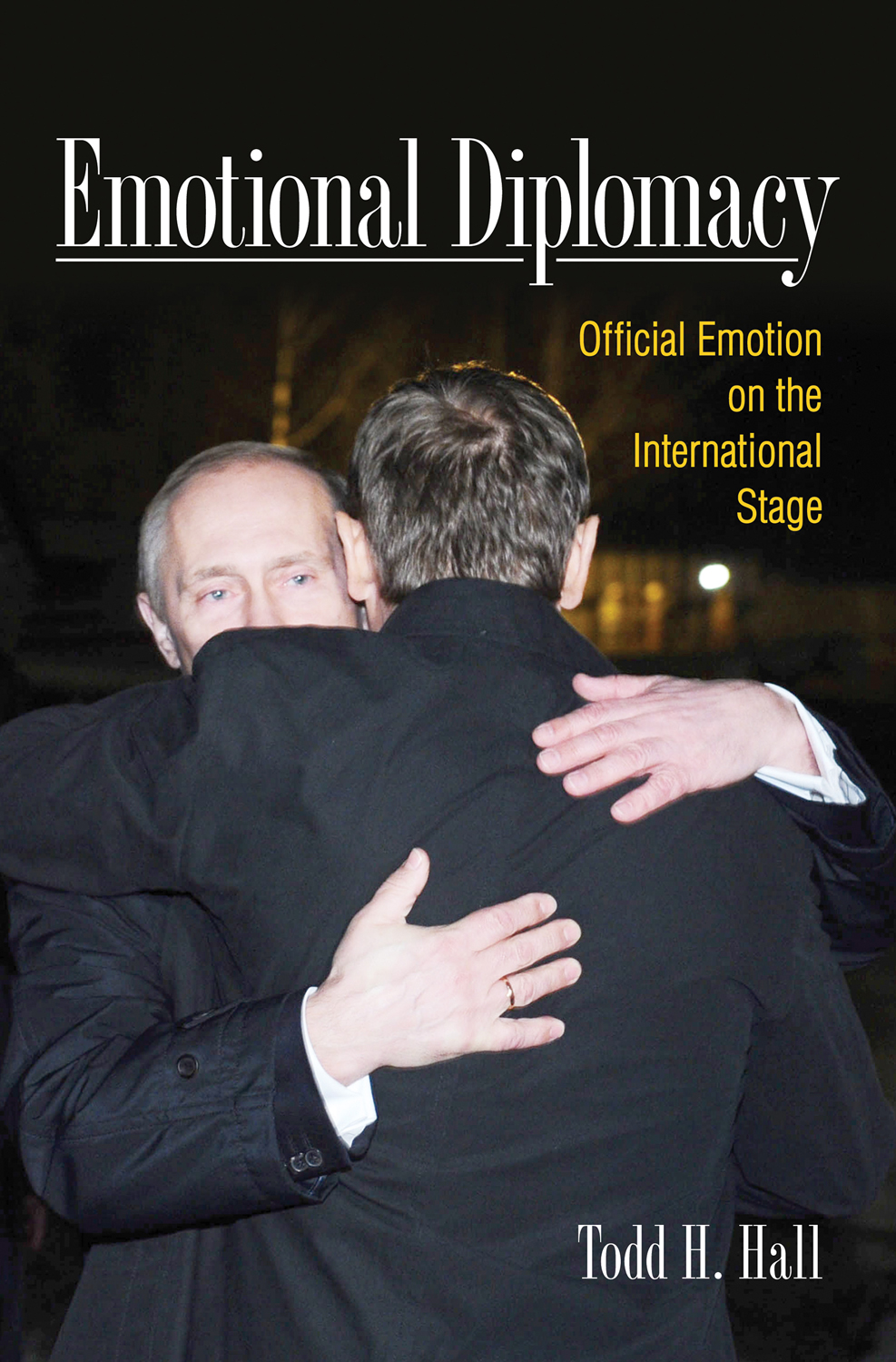
Emotional Diplomacy In Emotional Diplomacy, Todd H. Hall explores the politics of officially expressed emotion on the international stage, looking at the ways in which state actors strategically deploy emotional behavior to shape the perceptions of others. Examining diverse instances of emotional behavior, Hall reveals that official emotional displays are not simply cheap talk but rather play an important role in the strategies and interactions of state actors. Emotional diplomacy is more than rhetoric; as this book demonstrates, its implications extend to the provision of economic and military aid, great-power cooperation, and even the use of armed force.Emotional Diplomacy provides the theoretical tools necessary for understanding the nature and significance of state-level emotional behavior and offers new observations of how states seek reconciliation, strategically respond to unforeseen crises, and demonstrate resolve in the face of perceived provocations. Hall investigates three specific strands of emotional diplomacy: those rooted in anger, sympathy, and guilt. Presenting original research drawing on interviews and sources in five different languages, Hall provides new insights into the 1995–1996 Taiwan Strait Crisis, the post-9/11 reactions of China and Russia, and relations between West Germany and Israel after World War II. He also demonstrates how his arguments can be extended to further cases ranging from Sino-Japanese relations to diplomatic interactions in Latin America. Emotional Diplomacy offers a unique take on the intersection of strategic action and emotional display, offering a means for making sense of why states appear to behave emotionally. POLITICAL SCIENCE,International Relations,Diplomacy

Searching for a Cultural Diplomacy Recent studies on the meaning of cultural diplomacy in the twentieth century often focus on the United States and the Cold War, based on the premise that cultural diplomacy was a key instrument of foreign policy in the nation’s effort to contain the Soviet Union. As a result, the term “cultural diplomacy†has become one-dimensional, linked to political manipulation and subordination and relegated to the margin of diplomatic interactions. This volume explores the significance of cultural diplomacy in regions other than the United States or “western†countries, that is, regions that have been neglected by scholars so far—Eastern Europe, Asia, and the Middle East. By examining cultural diplomacy in these regions, the contributors show that the function of information and exchange programs differs considerably from area to area depending on historical circumstances and, even more importantly, on the cultural mindsets of the individuals involved. POLITICAL SCIENCE,International Relations,Diplomacy

A Different Kind of War At a time when the international community is again threatening some countries with sanctions, this book comes as a warning. It should be mandatory reading for all those politicians and their foreign-policy advisors who continue to consider sanctions an effective form of policy. The author not only offers us a critical, lucid, and well-informed survey of political developments in Iraq, but also a heart-rending account of the suffering of the Iraqi people. It was they who bore the brunt of the 13-year's sanctions, while the members of Saddam's regime continued to live in luxury and accumulate huge fortunes. H.-C. von Sponeck, the former “UN Humanitarian Coordinator for Iraq,†explores the UN's sanction policies against Iraq, their consequences, and the domestic conditions during this period. His extensive research is based on previously unpublished internal UN documents and discussions with UN decision makers (such as General Secretary Kofi Annan), Iraqi officials and politicians (including Saddam Hussein), and ordinary Iraqis. The author’s findings question who really benefited from the program, what role the UN Security Council and its various member states played, and whether there were then and are today alternatives to the UN's Iraq policies. POLITICAL SCIENCE,International Relations,Diplomacy
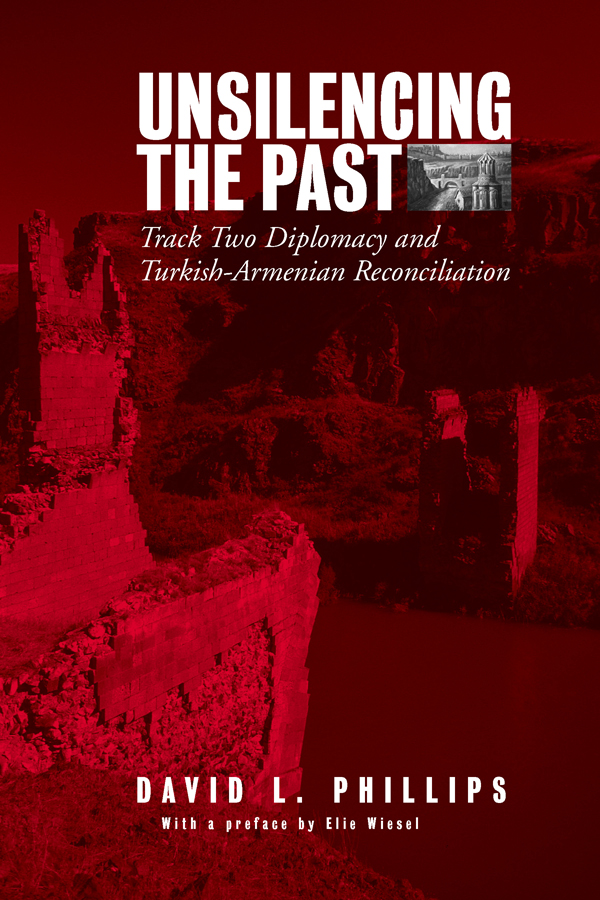
Unsilencing the Past The Turkish-Armenian conflict has lasted for nearly a century and still continues in attenuated forms to poison the relationship between these two peoples. The author, Senior Fellow and Deputy Director of the Center for Preventive Action at the Council on Foreign Relations and previously advisor to the United Nations, undertook, as head of the Turkish-Armenian Reconciliation Committee, to bring the two sides together and to work with them towards a peaceful resolution of the enmity that had made any contact between them taboo. His lively account of the difficult negotiations makes fascinating reading; it shows that the newly developed “track-two diplomacy†is an effective tool for reconciling even intractable foes through fostering dialog, contact and cooperation. POLITICAL SCIENCE,International Relations,Diplomacy

Kissinger on Kissinger In a series of riveting interviews, America's senior statesman discusses the challenges of directing foreign policy during times of great global tension. As National Security Advisor to Richard Nixon, Henry Kissinger transformed America's approach to diplomacy with China, the USSR, Vietnam, and the Middle East, laying the foundations for geopolitics as we know them today. Nearly fifty years later, escalating tensions between the US, China, and Russia are threatening a swift return to the same diplomatic game of tug-of-war that Kissinger played so masterfully. Kissinger on Kissinger is a series of faithfully transcribed interviews conducted by the elder statesman's longtime associate, Winston Lord, which captures Kissinger's thoughts on the specific challenges that he faced during his tenure as NSA, his general advice on leadership and international relations, and stunning portraits of the larger-than-life world leaders of the era. The result is a frank and well-informed overview of US foreign policy in the first half of the 70s—essential reading for anyone hoping to understand tomorrow's global challenges. POLITICAL SCIENCE,International Relations,Diplomacy

State Failure and State Weakness in a Time of Terror A Brookings Institution Press and World Peace Foundation publication The threat of terror, which flares in Africa and Indonesia, has given the problem of failed states an unprecedented immediacy and importance. In the past, failure had a primarily humanitarian dimension, with fewer implications for peace and security. Now nation-states that fail, or may do so, pose dangers to themselves, to their neighbors, and to people around the globe: preventing their failure, and reviving those that do fail, has become a strategic as well as a moral imperative. State Failure and State Weakness in a Time of Terror develops an innovative theory of state failure that classifies and categorizes states along a continuum from weak to failed to collapsed. By understanding the mechanisms and identifying the tell-tale indicators of state failure, it is possible to develop strategies to arrest the fatal slide from weakness to collapse. This state failure paradigm is illustrated through detailed case studies of states that have failed and collapsed (the Democratic Republic of the Congo, Sierra Leone, the Sudan, Somalia), states that are dangerously weak (Colombia, Indonesia, Sri Lanka, Tajikistan), and states that are weak but safe (Fiji, Haiti, Lebanon). POLITICAL SCIENCE,International Relations,Diplomacy

Stealth War China expert Robert Spalding reveals the shocking success China has had infiltrating American institutions and compromising our national security. The media often suggest that Russia poses the greatest threat to America's national security, but the real danger lies farther east. While those in power have been distracted and disorderly, China has waged a six-front war on America's economy, military, diplomacy, technology, education, and infrastructure--and they're winning. It's almost too late to undo the shocking, though nearly invisible, victories of the Chinese. In Stealth War, retired Air Force Brigadier General Robert Spalding reveals China's motives and secret attacks on the West. Chronicling how our leaders have failed to protect us over recent decades, he provides shocking evidence of some of China's most brilliant ploys, including: • Placing Confucius Institutes in universities across the United States that serve to monitor and control Chinese students on campus and spread communist narratives to unsuspecting American students. • Offering enormous sums to American experts who create investment funds that funnel technology to China. • Signing a thirty-year agreement with the US that allows China to share peaceful nuclear technology, ensuring that they have access to American nuclear know-how. Spalding's concern isn't merely that America could lose its position on the world stage. More urgently, the Chinese Communist Party has a fundamental loathing of the legal protections America grants its people and seeks to create a world without those rights. Despite all the damage done so far, Spalding shows how it's still possible for the U.S. and the rest of the free world to combat--and win--China's stealth war. POLITICAL SCIENCE,International Relations,Diplomacy
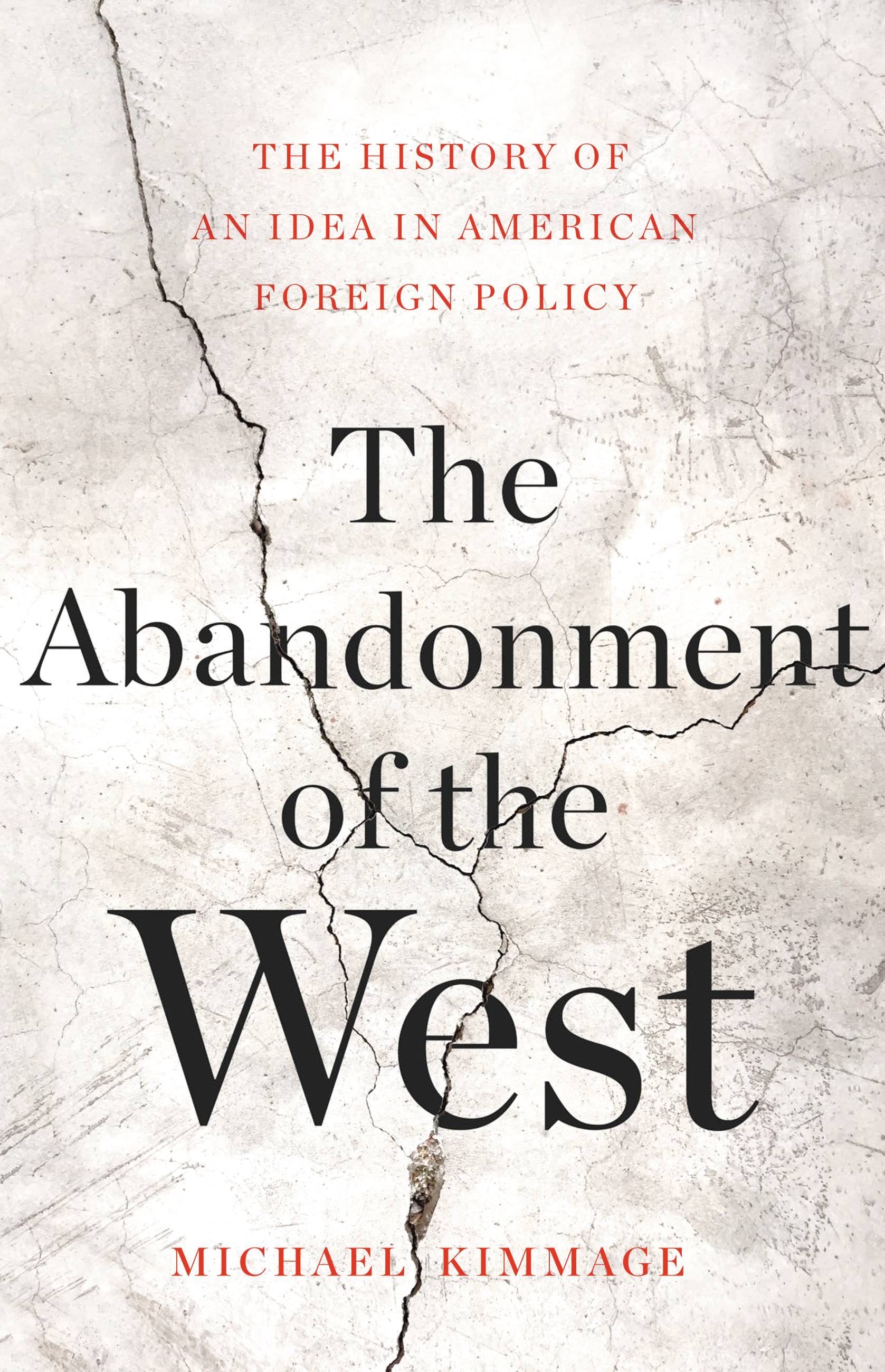
The Abandonment of the West This definitive portrait of American diplomacy reveals how the concept of the West drove twentieth-century foreign policy, how it fell from favor, and why it is worth saving. Throughout the twentieth century, many Americans saw themselves as part of Western civilization, and Western ideals of liberty and self-government guided American diplomacy. But today, other ideas fill this role: on one side, a technocratic "liberal international order," and on the other, the illiberal nationalism of "America First." In The Abandonment of the West, historian Michael Kimmage shows how the West became the dominant idea in US foreign policy in the first half of the twentieth century -- and how that consensus has unraveled. We must revive the West, he argues, to counter authoritarian challenges from Russia and China. This is an urgent portrait of modern America's complicated origins, its emergence as a superpower, and the crossroads at which it now stands. POLITICAL SCIENCE,International Relations,Diplomacy

America in the World Ranging from Benjamin Franklin, Alexander Hamilton, and Thomas Jefferson to Henry Kissinger, Ronald Reagan, and James Baker, America in the World tells the vibrant story of American diplomacy. Recounting the actors and events of U.S. foreign policy, Zoellick identifies five traditions that have emerged from America's encounters with the world: the importance of North America; the special roles trading, transnational, and technological relations play in defining ties with others; changing attitudes toward alliances and ways of ordering connections among states; the need for public support, especially through Congress; and the belief that American policy should serve a larger purpose. These traditions frame a closing review of post-Cold War presidencies, which Zoellick foresees serving as guideposts for the future. Both a sweeping work of history and an insightful guide to U.S. diplomacy past and present, America in the World serves as an informative companion and practical adviser to readers seeking to understand the strategic and immediate challenges of U.S. foreign policy during an era of transformation. POLITICAL SCIENCE,International Relations,Diplomacy

The Churchill Complex From one of its keenest observers, a brilliant, witty journey through the "Special Relationship" between Britain and America that has done so much to shape the world, from World War II to Brexit. It's impossible to understand the last 75 years of American history, through to Trump and Brexit, without understanding the Anglo-American relationship, and specifically the bonds between presidents and prime ministers. FDR of course had Churchill; JFK famously had Macmillan, his consigliere during the Cuban Missile Crisis. Reagan found his ideological soul mate in Thatcher, and George W. Bush found his fellow believer, in religion and in war, in Tony Blair. And now, of course, it is impossible to understand the populist uprising in either country, from 2016 to the present, without reference to Trump and Boris Johnson, though ironically, they are also the key to understanding the special relationship's demise. There are few things more certain in politics than that at some point, facing a threat to national security, a leader will evoke Winston Churchill to stand for brave leadership (and Neville Chamberlain to represent craven weakness). As Ian Buruma shows, in his dazzling short tour de force of storytelling and analysis, the mantle has in fact only grown more oppressive as nuanced historical understanding fades and is replaced by shallow myth. Absurd as it is to presume to say what Churchill would have thought about any current event, it's relatively certain he would have been horrified by the Iraq War and Brexit, to name two episodes dense with "Finest Hour" analogizing. But The Churchill Complex is much more than a reflection on the weight of Churchill's legacy and its misuses. At its heart is a series of shrewd and absorbing character studies of the president-prime minster dyads, which in Ian Buruma's gifted hands serve as a master class in politics, diplomacy and abnormal psychology. It's never been a relationship of equals: from Churchill's desperate cajoling and conniving to keep FDR on side in the war on, British prime ministers have put much more stock in the relationship than their US counterparts did. For England, resigned to the loss of its once-great empire and the diminishment of its power, its close kinship to the world's greatest superpower would give it continued relevance, and serve as leverage to keep continental Europe in its place. As Buruma shows, this was almost always fool's gold. And now, even as the links between the Brexit vote and the 2016 US election are coming into sharper focus, the Anglo-American alliance has floundered on the rocks of the isolationism that is one of 2016's signal legacies. The Churchill Complex may not have a happy ending, but as with Ian Buruma's other works, piercing lucidity and elegant prose is its own form of lasting comfort. POLITICAL SCIENCE,International Relations,Diplomacy

Collateral Damage "@realDonaldTrump: The wacky ambassador that the UK foisted on the United States is not someone we are thrilled with, a very stupid guy ... We will no longer deal with him." Kim Darroch is one of the UK's most experienced and respected diplomats, and this unvarnished, behind-the-scenes account will reveal the inside story behind his resignation; describe the challenges of dealing with the Trump White House; and offer a diplomat's perspective on Brexit, and how it looked to Britain's closest ally. Darroch was the British Ambassador to the US as the age of Trump dawned and Brexit unfolded. He explains why the British embassy expected a Trump victory from as early as February 2016, what part every key figure - from Steve Bannon to Sarah Sanders - has played in Trump's administration, and what balanced policy makers on both sides of the Atlantic should consider during this era of seismic change and populist politics. A riveting account from the best-informed insider, Collateral Damage charts the strangest and most convulsive period in the recent history of Britain and the US - and shows how 30 months threatened to overturn three centuries of history. POLITICAL SCIENCE,International Relations,Diplomacy
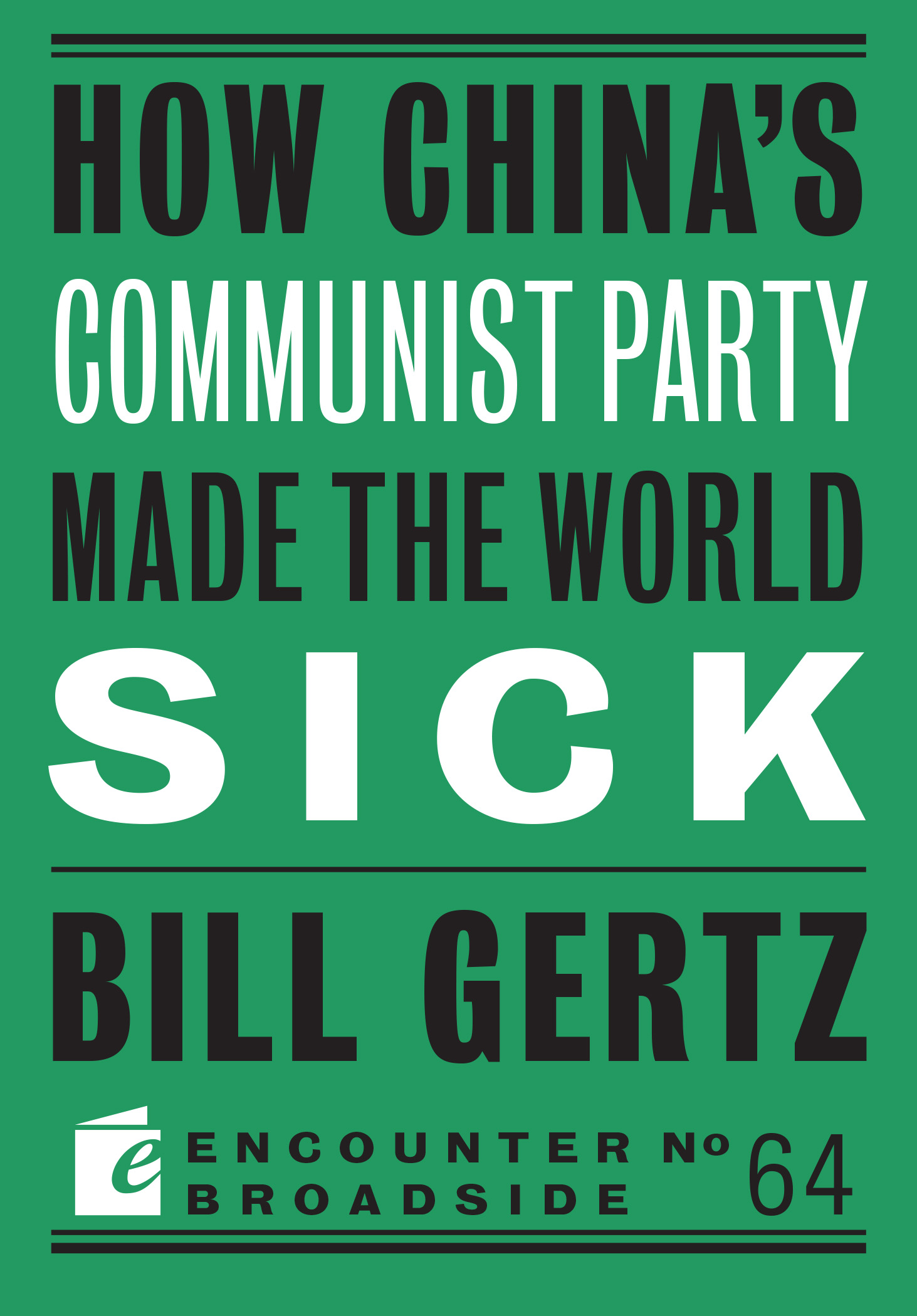
How China's Communist Party Made the World Sick The outbreak of a deadly new form of pneumonia that began in Wuhan, China, in December 2019 has shown the world that the regime in Beijing poses the most serious threat to world peace and freedom since the Soviet Union. Early missteps by China’s ruling Communist Party — repressing doctors who sought to alert China and the world to the dangers of the novel coronavirus and permitting millions to travel out of Wuhan for a holiday — caused the global pandemic now devastating populations and economies around the world. In this important essay, Bill Gertz shows how China’s lies and obfuscations imperiled the world. POLITICAL SCIENCE,International Relations,Diplomacy

Chinese People’s Diplomacy and Developmental Relations with East Asia As China takes up the mantle of a global power, its diplomatic policy has changed significantly as it assumes a role of regional leadership. Until recently, China has not tended to talk about its developmental strategy as a model for others to follow. Since the rise of Xi Jinping this has changed, and the state has become more open in sharing its developmental experiences with its neighbours. This has become an important part of China’s diplomatic relations with other countries in East Asia. Beijing has also emphasized people-to-people diplomacy, with outward tourism and other exchanges of peoples seen as an important part of building stronger relations with its neighbours. The chapters in this book all address different elements of this strategy, looking at China’s bilateral relationships with other East Asian countries in terms of developmental relations and the increasing mutual exposure of their citizens. This book will be of great interest to scholars of Chinese diplomacy, especially those with a particular interest in soft power. POLITICAL SCIENCE,International Relations,Diplomacy
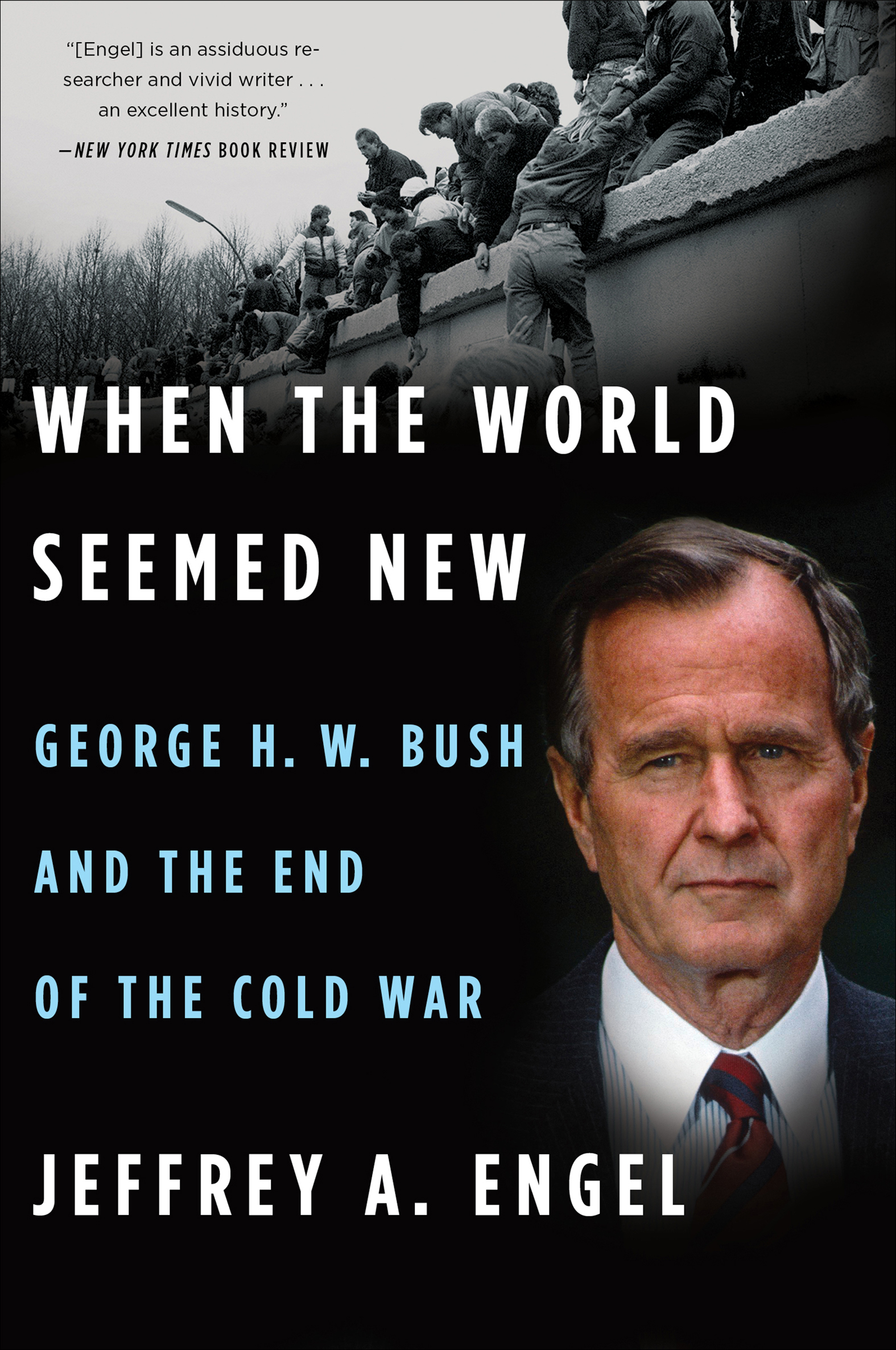
When the World Seemed New “Engel’s excellent history forms a standing—if unspoken—rebuke to the retrograde nationalism espoused by Donald J. Trump.†—The New York Times Book Review The collapse of the Soviet Union was the greatest shock to international affairs since World War II. In that perilous moment, Saddam Hussein invaded Kuwait and regimes throughout Eastern Europe and Asia teetered between democratic change and new authoritarian rule. President Bush faced a world in turmoil that might easily have tipped into an epic crisis. As presidential historian Jeffrey Engel reveals in this page-turning history, Bush rose to the occasion brilliantly. Using handwritten letters and direct conversations—some revealed here for the first time—with heads of state throughout Asia and Europe, Bush knew when to push, when to cajole, and when to be patient. Based on previously classified documents, and interviews with all the principals, When the World Seemed New is a riveting, fly-on-the-wall account of a president with his calm hand on the tiller, guiding the nation from a moment of great peril to the pinnacle of global power. “An absorbing book.â€â€”The Wall Street Journal “By far the most comprehensive—and compelling—account of these dramatic years thus far.â€â€”The National Interest “A remarkable book about a remarkable person. Southern Methodist University professor Jeffrey Engel describes in engrossing detail the patient and sophisticated strategy President George H.W. Bush pursued as the Cold War came to an end.â€â€”The Dallas Morning News POLITICAL SCIENCE,International Relations,Diplomacy

Why Nation-Building Matters No one likes nation-building. The public dismisses it. Politicians criticize it. The traditional military disdains it, and civilian agencies lack the blueprint necessary to make it work. Yet functioning states play a foundational role in international security and stability. Left unattended, ungoverned spaces can produce crises from migration to economic collapse to terrorism. Keith W. Mines has taken part in nation-building efforts as a Special Forces officer, diplomat, occupation administrator, and United Nations official. In Why Nation-Building Matters he uses cases from his own career to argue that repairing failed states is a high-yield investment in our own nation’s global future. Eyewitness accounts of eight projects––in Colombia, Grenada, El Salvador, Somalia, Haiti, Darfur, Afghanistan, and Iraq—inform Mines’s in-depth analysis of how foreign interventions succeed and fail. Building on that analysis, he establishes a framework for nation-building in the core areas of building security forces, economic development, and political consolidation that blend soft and hard power into an effective package. Grounded in real-world experience, Why Nation-Building Matters is an informed and essential guide to meeting one of the foremost challenges of our foreign policy present and future. POLITICAL SCIENCE,International Relations,Diplomacy
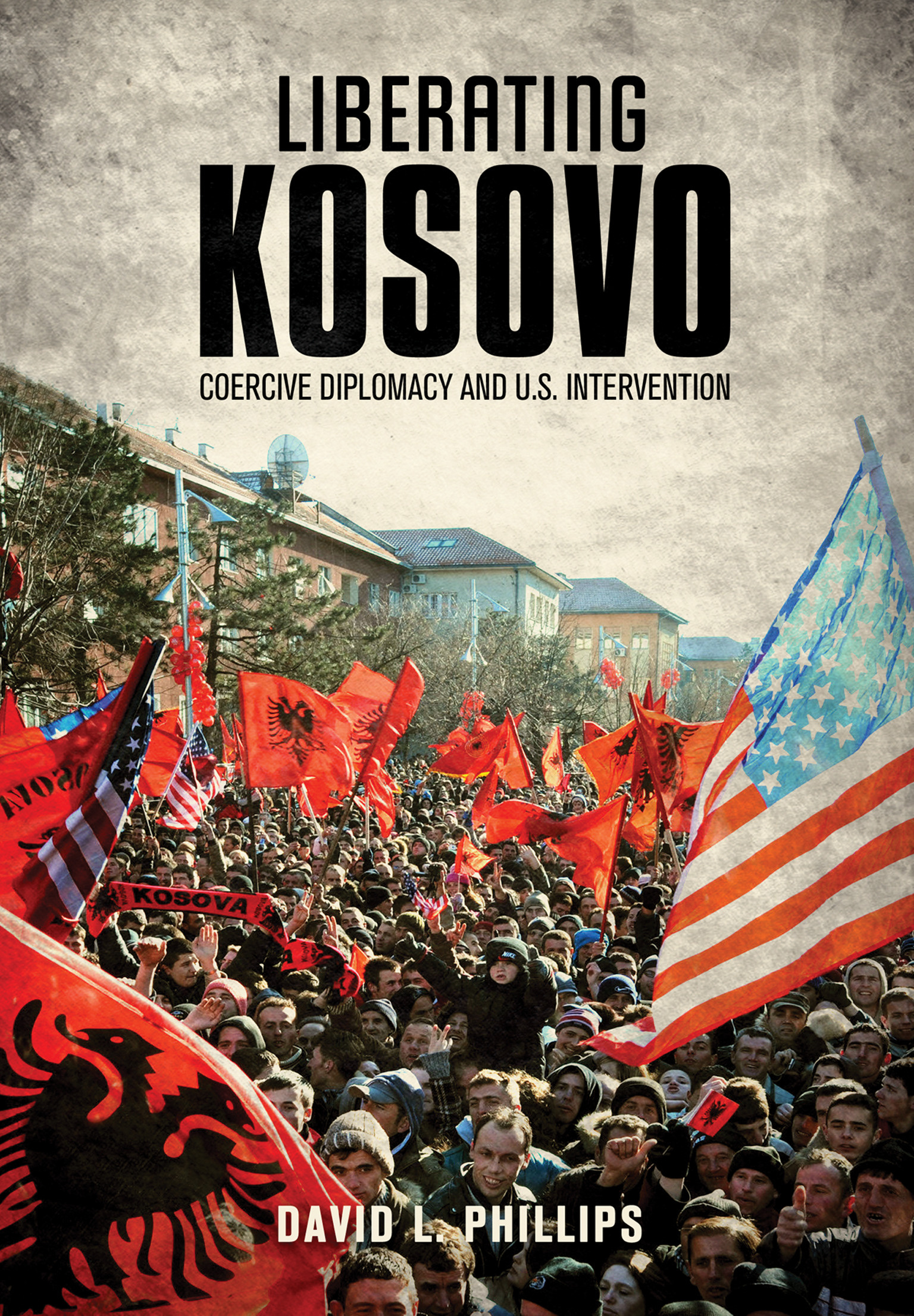
Liberating Kosovo A compelling account of the diplomatic and military actions that led to Kosovo's independence and their implications for future U.S. and UN interventions. Kosovo, after its incorporation into the Serbian Republic of Yugoslavia, became increasingly restive during the 1990s as Yugoslavia plunged into internal war and Kosovo's ethnic Albanian residents (Kosovars) sought autonomy. In March 1999, NATO forces began airstrikes against targets in Kosovo and Serbia in an effort to protect Kosovars against persecution. The bombing campaign ended in June 1999, and Kosovo was placed under transitional UN administration while negotiations on its status ensued. Kosovo eventually declared independence in 2008. Despite internal political tension and economic problems, the new nation has been recognized by many other countries and most of its inhabitants welcome its separation from Serbia. In Liberating Kosovo, David Phillips offers a compelling account of the negotiations and military actions that culminated in Kosovo's independence. Drawing on his own participation in the diplomatic process and interviews with leading participants, Phillips chronicles Slobodan Milosevic's rise to power, the sufferings of the Kosovars, and the events that led to the disintegration of Yugoslavia. He analyzes how NATO, the United Nations, and the United States employed diplomacy, aerial bombing, and peacekeeping forces to set in motion the process that led to independence for Kosovo. He also offers important insights into a critical issue in contemporary international politics: how and when the United States, other nations, and NGOs should act to prevent ethnic cleansing and severe human-rights abuses. POLITICAL SCIENCE,International Relations,Diplomacy

To the Secretary A former American diplomat reveals a disconnect between Washington policymakers and those who work in US embassies. When the world awoke on November 28, 2010, and read the first of the 251,287 State Department cables made public by WikiLeaks, Italian Foreign Minister Franco Frattini warned, “It will be the September 11th of world diplomacy.†The WikiLeaks scandal certainly stirred tempers around the world, but it was not the implosion that many leaders expected: rather, it shed a new spotlight on the work of the U.S. foreign service. In To the Secretary, Mary Thompson-Jones explores the most fascinating and overlooked of these cables to offer an unparalleled window into the day-to-day work of U.S. diplomats, demystifying the lives of those who implement America’s foreign policy across the globe. From the story of Bulgaria’s Aleksi “the Tractor†Petrov to disappearing ballot ink in Ukraine, a Honduran coup d’état, or disaster relief for a devastated Haiti, To the Secretary depicts the work of ambassadors and foreign service officers through their firsthand narratives dealing with crises, corruption, and testy world leaders. Negotiating distinctly un-American customs and corridors of power, these shrewd brokers in embassies from Argentina to Zimbabwe worked tirelessly to promote American diplomacy in a world frequently hostile to the United States. To the Secretary also reveals the disconnect that diplomats face at home, guided by conflicting approaches from multiple Washington stakeholders intent on their own agenda, often unaware of realities on the ground. In an honest assessment of America’s foreign policy challenges, Thompson-Jones describes the deepening gulf between decision makers in Washington and their diplomats in the field. From misinterpreted analyses of anti-Americanism to Washington’s unwillingness to send resources to support diplomatic activities that could make a difference, To the Secretary shows what policymakers can learn from diplomats abroad—and how this can strengthen America’s place in an unstable world. POLITICAL SCIENCE,International Relations,Diplomacy
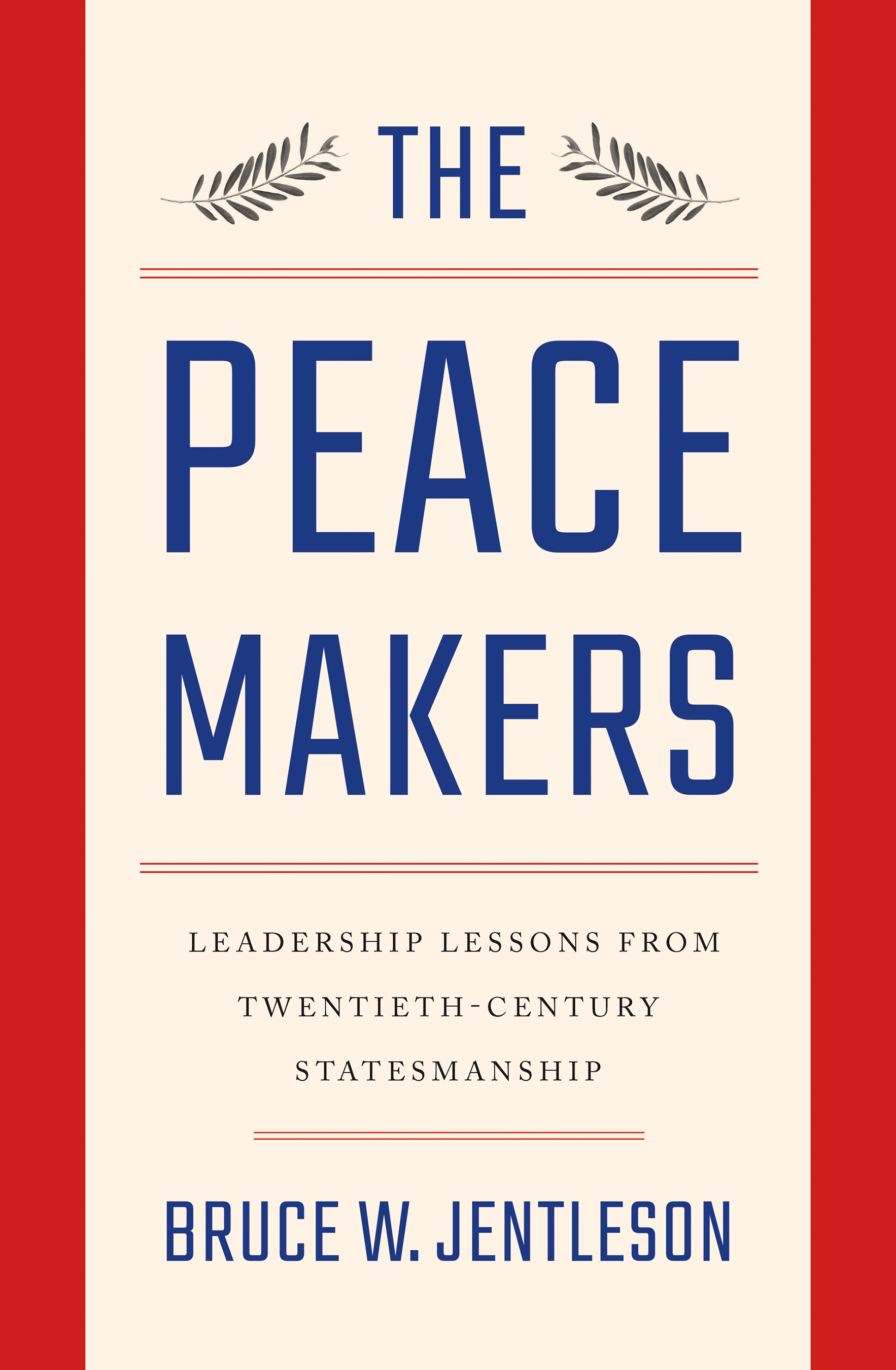
The Peacemakers In the twentieth century, great leaders played vital roles in making the world a fairer and more peaceful place. How did they do it? What lessons can be drawn for the twenty-first-century global agenda? Those questions are at the heart of The Peacemakers, a kind of global edition of John F. Kennedy’s Profiles in Courage. Writing at a time when peace seems elusive and conflict endemic, when tensions are running high among the major powers, when history has come roaring back, when democracy and human rights are yet again under siege, when climate change is moving from future to present tense, and when transformational statesmanship is so needed, Bruce W. Jentleson shows how twentieth-century leaders of a variety of types—national, international institutional, sociopolitical, nongovernmental—rewrote the zero-sum scripts they were handed and successfully made breakthroughs on issues long thought intractable. The stories are fascinating: Henry Kissinger, Zhou Enlai, and the U.S.-China opening; Mikhail Gorbachev and the end of the Cold War; Dag Hammarskjöld’s exceptional effectiveness as United Nations secretary-general; Nelson Mandela and South African reconciliation; Yitzhak Rabin seeking Arab-Israeli peace; Mahatma Gandhi as exemplar of anticolonialism and an apostle of nonviolence; Lech Walesa and ending Soviet bloc communism; Gro Harlem Brundtland and fostering global sustainability; and a number of others. While also taking into account other actors and factors, Jentleson tells us who each leader was as an individual, why they made the choices they did, how they pursued their goals, and what they were (and weren’t) able to achieve. And not just fascinating, but also instructive. Jentleson draws out lessons across the twenty-first-century global agenda, making clear how difficult peacemaking is, while powerfully demonstrating that it has been possible—and urgently stressing how necessary it is today. An ambitious book for ambitious people, The Peacemakers seeks to contribute to motivating and shaping the breakthroughs on which our future so greatly depends. POLITICAL SCIENCE,International Relations,Diplomacy
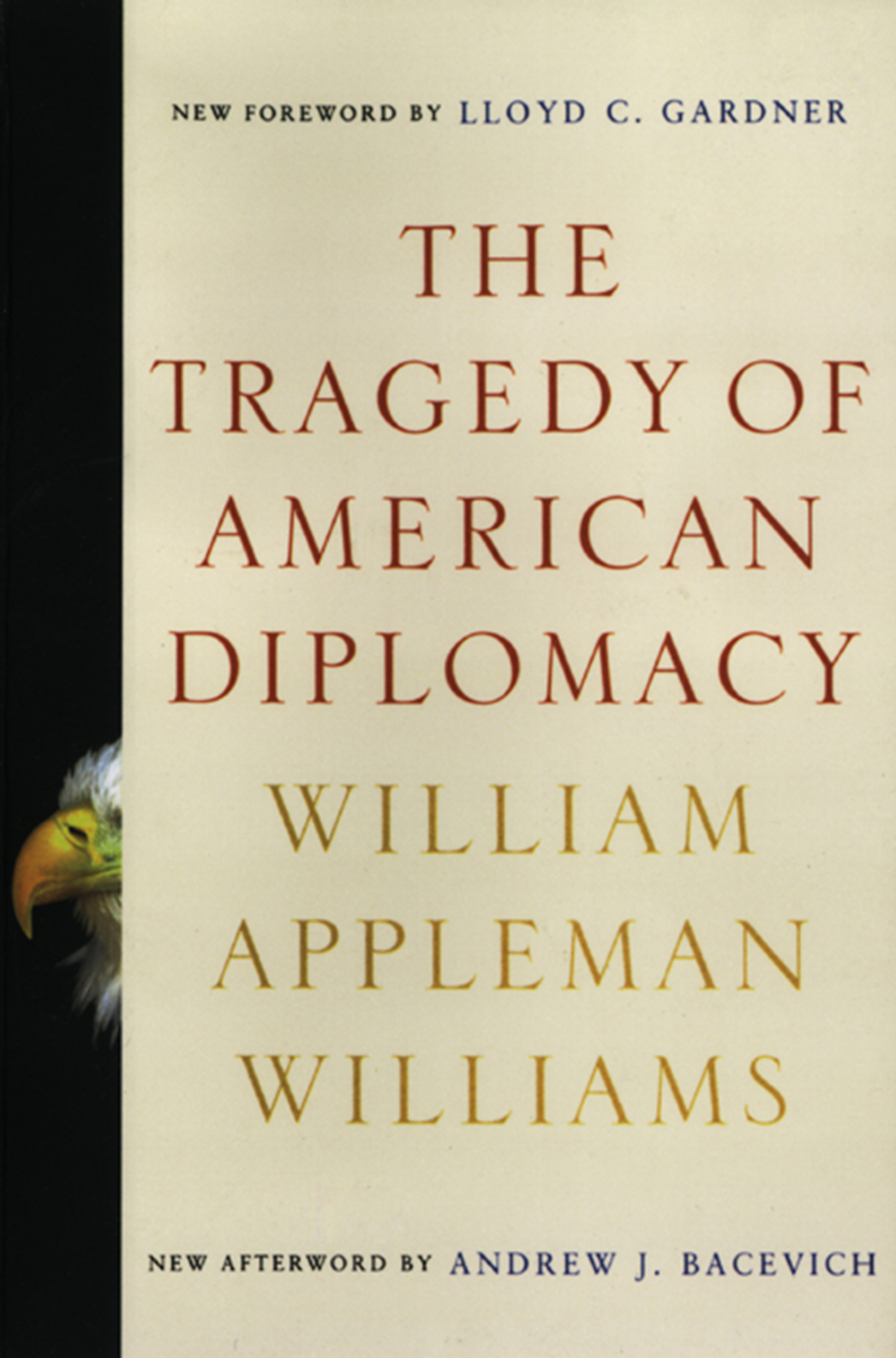
The Tragedy of American Diplomacy (50th Anniversary Edition) “A brilliant book on foreign affairs.â€â€”Adolf A. Berle Jr., New York Times Book Review This incisive interpretation of American foreign policy ranks as a classic in American thought. First published in 1959, the book offered an analysis of the wellsprings of American foreign policy that shed light on the tensions of the Cold War and the deeper impulses leading to the American intervention in Vietnam. William Appleman Williams brilliantly explores the ways in which ideology and political economy intertwined over time to propel American expansion and empire in the nineteenth and twentieth centuries. The powerful relevance of Williams’s interpretation to world politics has only been strengthened by recent events in Central Asia and the Persian Gulf. Williams allows us to see that the interests and beliefs that once sent American troops into Texas and California, or Latin America and East Asia, also propelled American forces into Iraq. POLITICAL SCIENCE,International Relations,Diplomacy

How to Make Love to a Despot After generations of foreign policy failures, the United States can finally try to make the world safer—not by relying on utopian goals but by working pragmatically with nondemocracies. Since the end of the Second World War, the United States has sunk hundreds of billions of dollars into foreign economies in the hope that its investments would help remake the world in its own image—or, at the very least, make the world “safe for democracy.†So far, the returns have been disappointing, to say the least. Pushing for fair and free elections in undemocratic countries has added to the casualty count, rather than taken away from it, and trying to eliminate corruption entirely has precluded the elimination of some of the worst forms of corruption. In the Middle East, for example, post-9/11 interventionist campaigns in Afghanistan and Iraq have proved to be long, costly, and, worst of all, ineffective. Witnessing the failure of the utopian vision of a world full of market-oriented democracies, many observers, both on the right and the left, have begun to embrace a dystopian vision in which the United States can do nothing and save no one. Accordingly, calls to halt all assistance in undemocratic countries have grown louder. But, as Stephen D. Krasner explains, this cannot be an option: weak and poorly governed states pose a threat to our stability. In the era of nuclear weapons and biological warfare, ignoring troubled countries puts millions of American lives at risk. “The greatest challenge for the United States now,†Krasner writes, “is to identify a set of policies that lie between the utopian vision that all countries can be like the United States . . . and the dystopian view that nothing can be done.†He prescribes a pragmatic new course of policy. Drawing on decades of research, he makes the case for “good enough governanceâ€â€”governance that aims for better security, better health, limited economic growth, and some protection of human rights. To this end, Krasner proposes working with despots to promote growth. In a world where a single terrorist can kill thousands or even hundreds of thousands of people, the United States does not have the luxury of idealistically ignoring the rest of the world. But it cannot remake the world in its own image either. Instead, it must learn how to make love to despots. POLITICAL SCIENCE,International Relations,Diplomacy
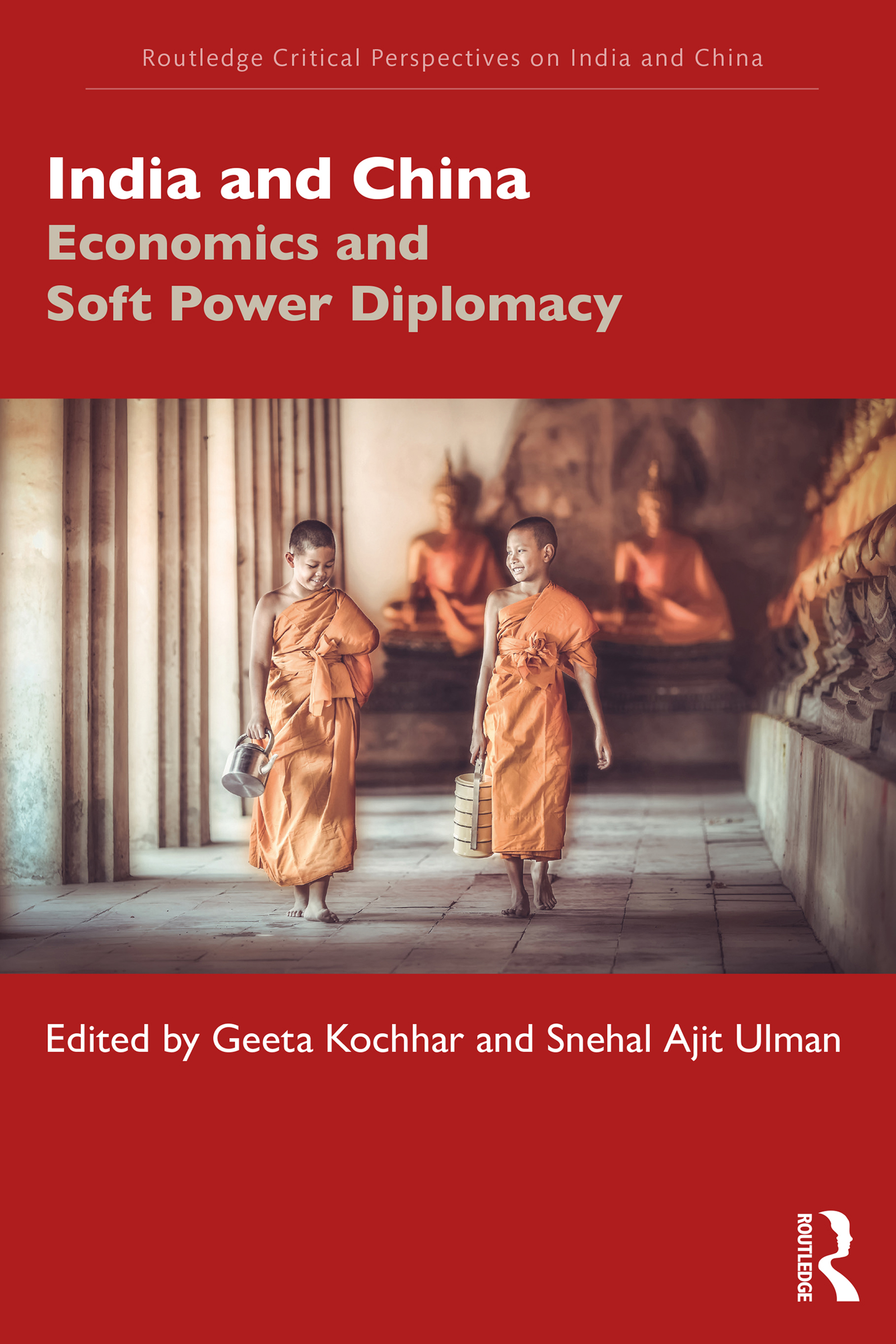
India and China This book looks at the changing dynamics of diplomacy of the two emerging global powers – India and China. It examines trade relations, cultural ties and economic engagements of both countries and their shifting influence in the region surrounding them. This volume takes an in-depth look at the trade and economic strategies of India and China through the prism of soft power diplomacy. It reflects on the challenges the two countries face over bilateral trade negotiations, BRICS and China’s Silk Road project, along with other issues of foreign policy. The book underlines the decisive role of the soft power approach and greater people-to-people contact in the global strategies of India and China and in fostering greater cooperation in the region. The book will be of great interest to researchers and students of international relations, political science, public policy and international communications. It will also be useful for think tanks, policy makers and general readers who are interested in the India-China relationship and the politics of soft power diplomacy. POLITICAL SCIENCE,International Relations,Diplomacy

Spies and Their Masters This book delves into the secret histories of the CIA, the FBI, and British and Italian intelligence to study how policymakers can control intelligence agencies and when these agencies will try to remove their own government. For every government they serve, intelligence agencies are both a threat and a necessity. They often provide vital information for national security, but the secrets they possess can also be used against their own masters. This book introduces subversion paradox theory to provide a social scientific explanation of the unequal power dynamic resulting from an often fraught relationship between agencies and their ‘masters’. The author also makes a case for the existence of ‘deep state’ conspiracies, including in highly developed democracies, and cautions those who denounce their existence that trying to control intelligence by politicizing it is likely to backfire. An important intervention in the field of intelligence studies, this book will be indispensable for intelligence professionals and policymakers in understanding and bridging the cultural divide between these two groups. It will also make for a fascinating and informative read to scholars and researchers of diplomacy, foreign policy, international relations, strategic and defence studies, security studies, political studies, policymaking and comparative politics. POLITICAL SCIENCE,International Relations,Diplomacy
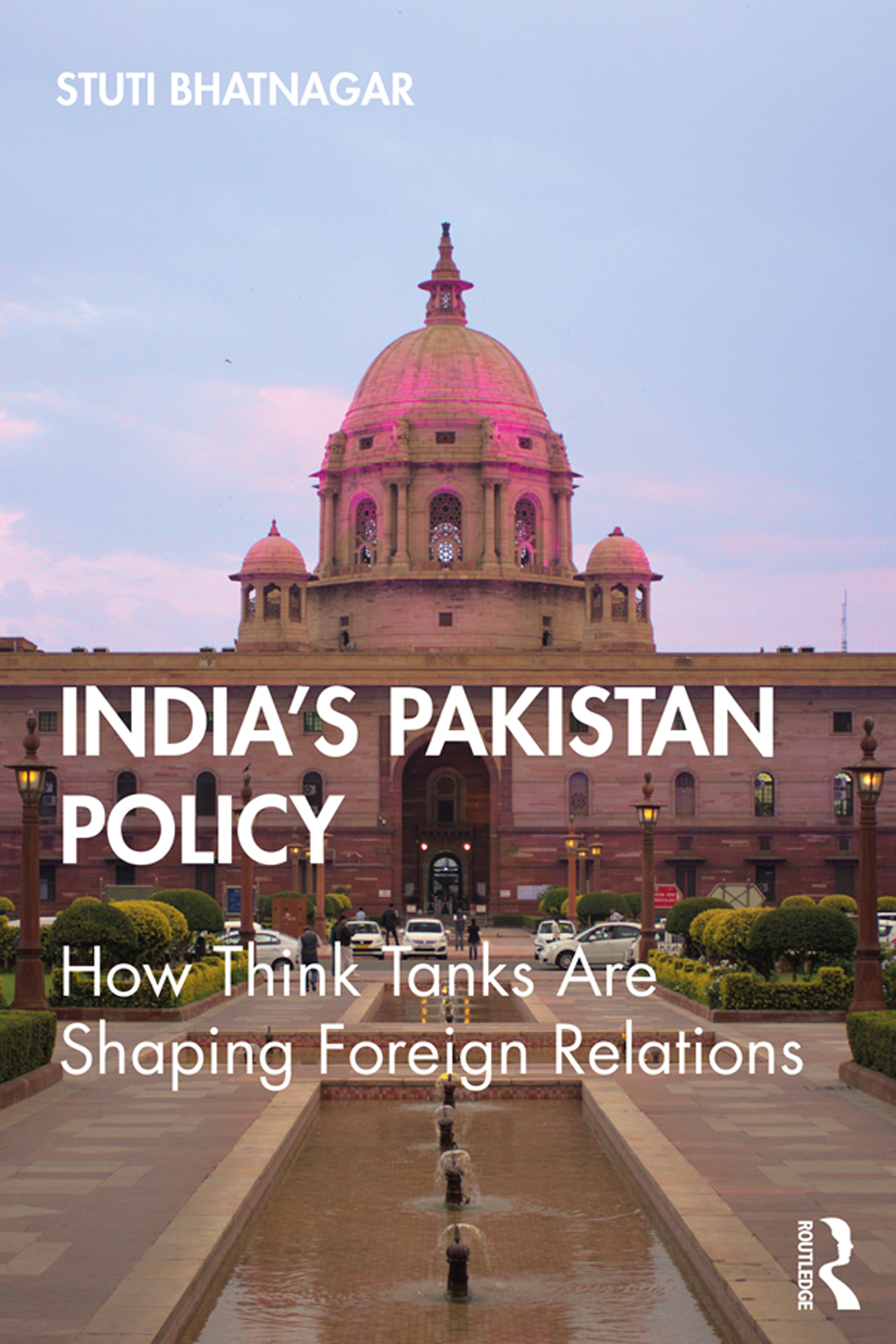
India's Pakistan Policy This book critically examines the role of think tanks as foreign policy actors. It looks at the origins and development of foreign policy think tanks in India and their changing relevance and position as agents within the policy-making process. The book uses a comparative framework and explores the research discourse of prominent Indian think tanks, particularly on the India–Pakistan dispute, and offers unique insights and perspectives on their research design and methodology. It draws attention to the policy discourse of think tanks during the Composite Dialogue peace process between India and Pakistan and the subsequent support from the government which further expanded their role. One of the first books to offer empirical analyses into the role of these organisations in India, this book highlights the relevance of and the crucial role that these institutions have played as non-state policy actors. Insightful and topical, this book will be of interest to researchers focused on international relations, foreign policy analysis and South Asian politics. It would also be a good resource for students interested in a theoretical understanding of foreign policy institutions in general and Indian foreign policy in particular. POLITICAL SCIENCE,International Relations,Diplomacy
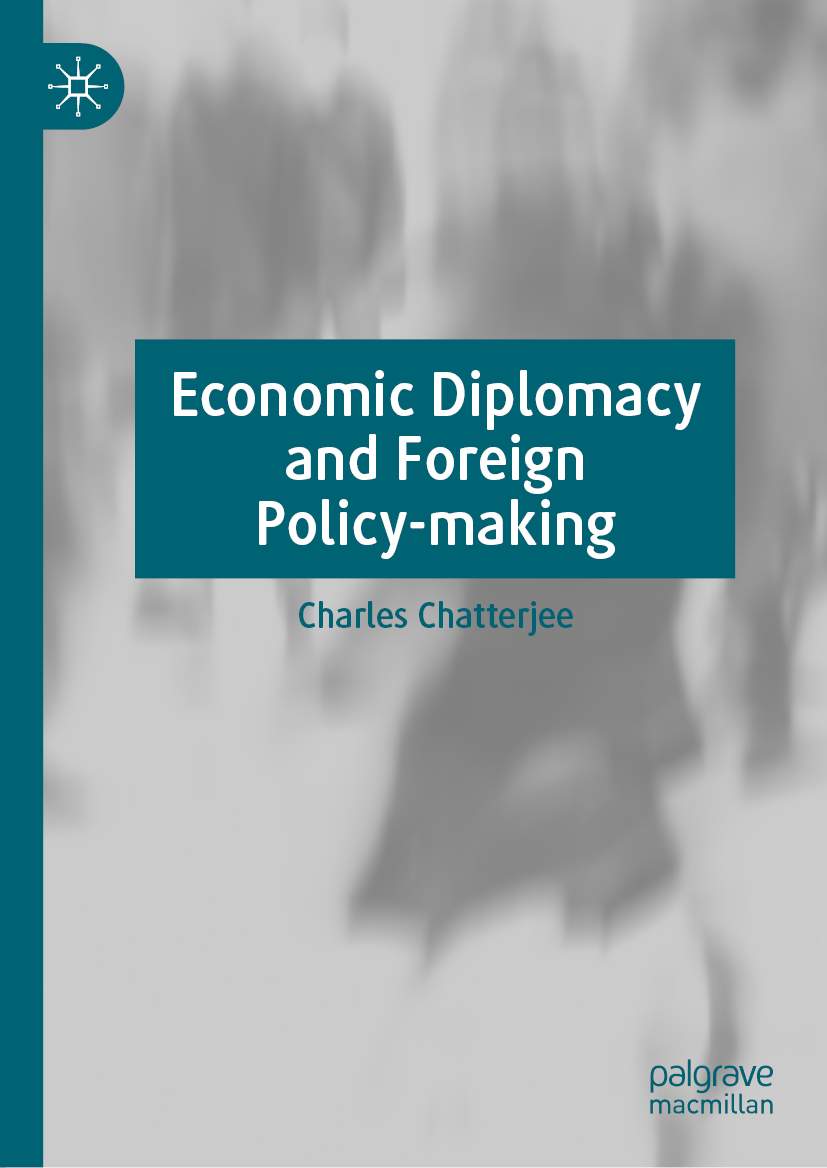
Economic Diplomacy and Foreign Policy-making This book aims to identify what components are needed for economic diplomacy in today’s rapidly changing world, looking at the nature, focus and tenets of economic diplomacy, and the differences between economic diplomacy and commercial diplomacy. Further, it considers the new kind of diplomacy that will be required for emerging markets, in contrast to maintaining the traditional techniques used for economic diplomacy between states. The author emphasises the negotiating techniques necessary for successfully engaging in economic diplomacy in the current diplomatic atmosphere. Importantly, it also discusses how to pursue economic diplomacy at international fora and with regard to private foreign investments. Lastly, it addresses the role of non-governmental organisations in economic diplomacy. Given its scope, the book will benefit not only practicing diplomats, but also graduate students. POLITICAL SCIENCE,International Relations,Diplomacy
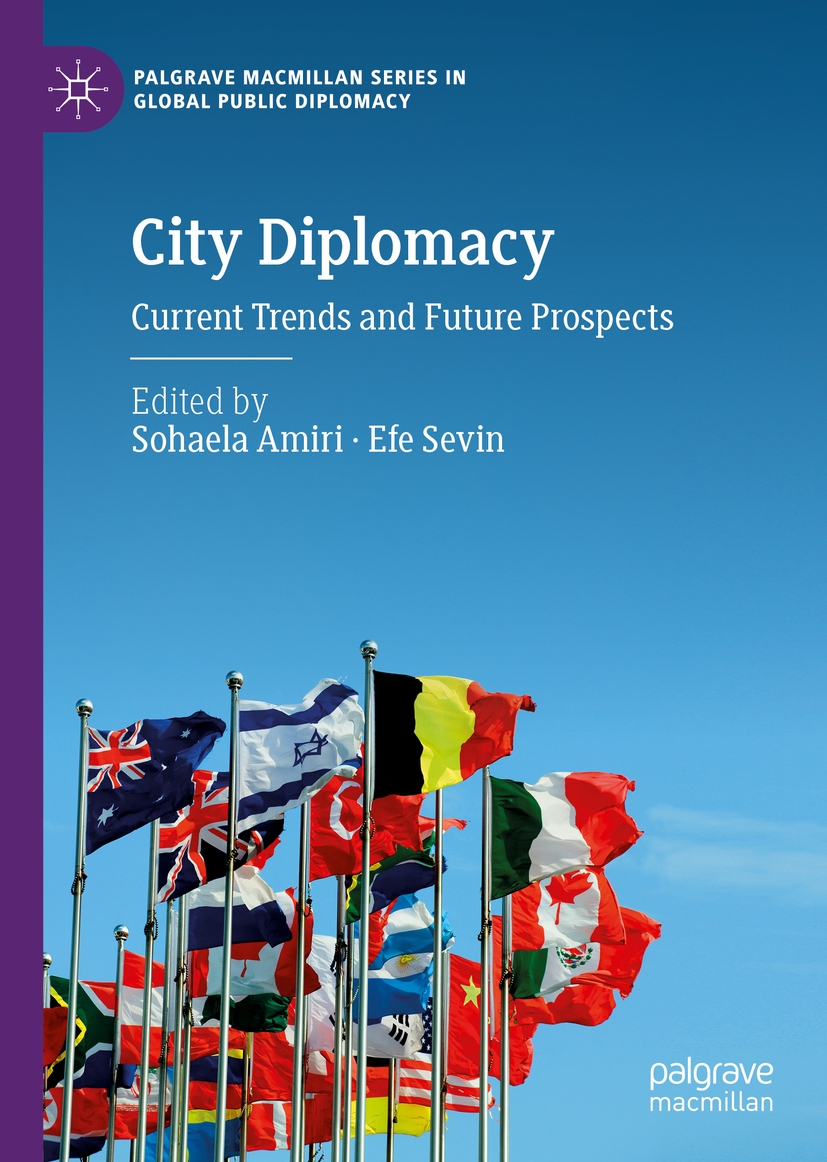
City Diplomacy This edited volume provides an inclusive explanation of what, why, and how cities interact with global counterparts as well as with nation states, non-governmental organizations, and foreign publics. The chapters present theoretical and analytical approaches to the study of city diplomacy as well as case studies to capture the nuances of the practice. By bringing together a diverse group of authors in terms of their geographic location, academic and practitioner backgrounds, the volume speaks to multiple disciplines, including diplomacy, political science, communication, sociology, marketing and tourism. POLITICAL SCIENCE,International Relations,Diplomacy
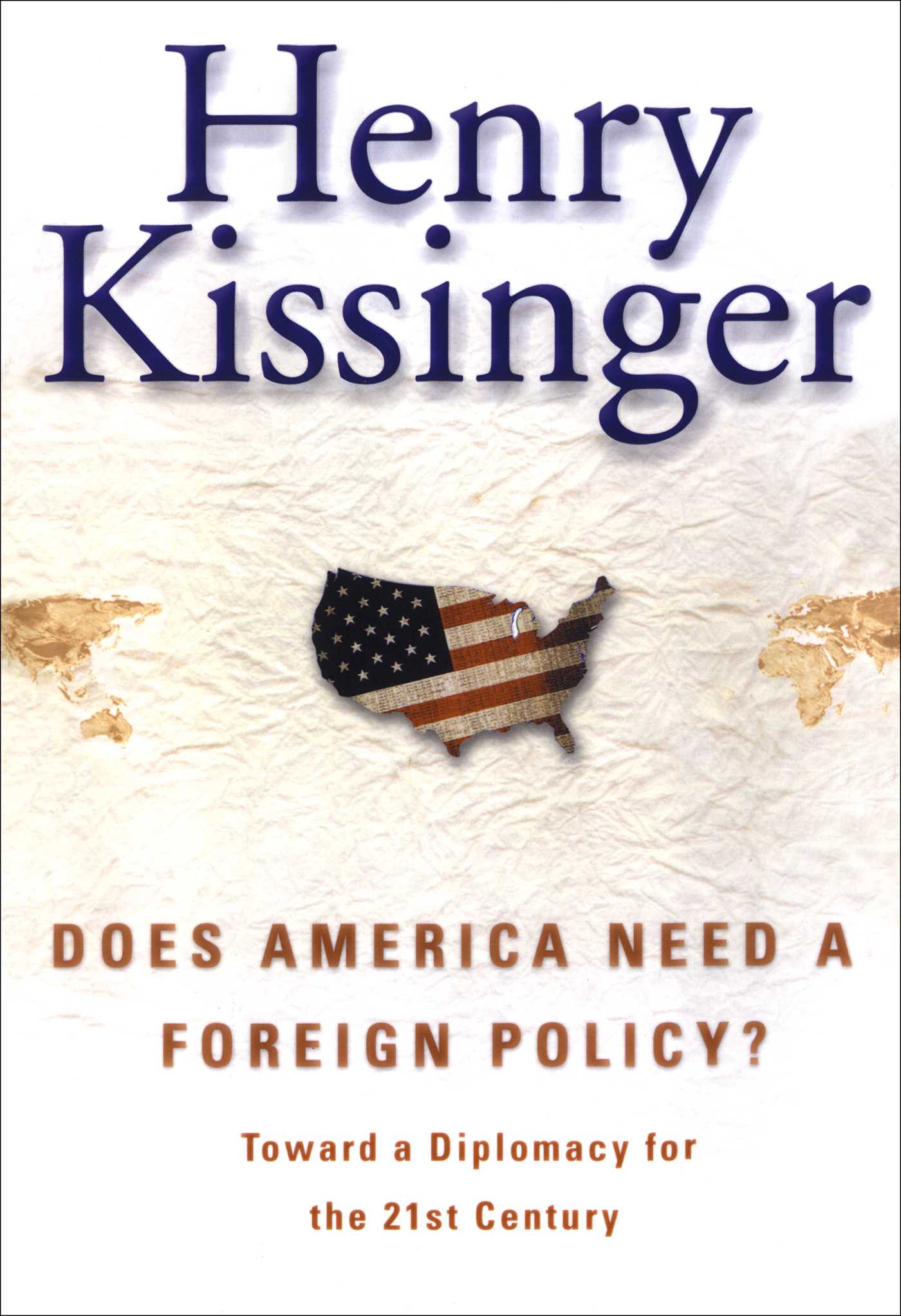
Does America Need a Foreign Policy? In this timely, thoughtful, and important book, at once far-seeing and brilliantly readable, America's most famous diplomatist explains why we urgently need a new and coherent foreign policy and what our foreign policy goals should be in the post-Cold War world of globalization. Dr. Henry Kissinger covers the wide range of problems facing the United States at the beginning of a new millennium and a new presidency, with particular attention to such hot spots as Vladimir Putin's Russia, the new China, the globalized economy, and the demand for humanitarian intervention. He challenges Americans to understand that our foreign policy must be built upon America's permanent national interests, defining what these are, or should be, in the year 2001 and for the foreseeable future. Here Dr. Kissinger shares with readers his insights into the foreign policy problems and opportunities that confront the United States today, including the challenge to conventional diplomacy posed by globalization, rapid capital movement, and instant communication; the challenge of modernizing China; the impact of Russia's precipitous decline from superpower status; the growing estrangement between the United States and Europe; the questions that arise from making "humanitarian intervention" a part of "the New Diplomacy"; and the prospect that America's transformation into the one remaining superpower and global leader may unite other countries against presumed imperial ambitions. Viewing America's international position through the immediate lens of policy choices rather than from the distant hindsight of historical analysis, Dr. Kissinger takes an approach to the country's current role as the world's dominant power that offers both an invaluable perspective on the state of the Union in global affairs and a careful, detailed prescription on exactly how we must proceed. In seven accessible chapters, Does America Need a Foreign Policy? provides a crystalline assessment of how the United States' ascendancy as the world's dominant presence in the twentieth century may be effectively reconciled with the urgent need in the twenty-first century to achieve a bold new world order. By examining America's present and future relations with Russia, China, Europe, the Middle East, Africa, Latin America, and Asia, in conjunction with emerging concerns such as globalization, nuclear weapons proliferation, free trade, and the planet's eroding natural environment, Dr. Kissinger lays out a compelling and comprehensively drawn vision for American policy in approaching decades. POLITICAL SCIENCE,International Relations,General
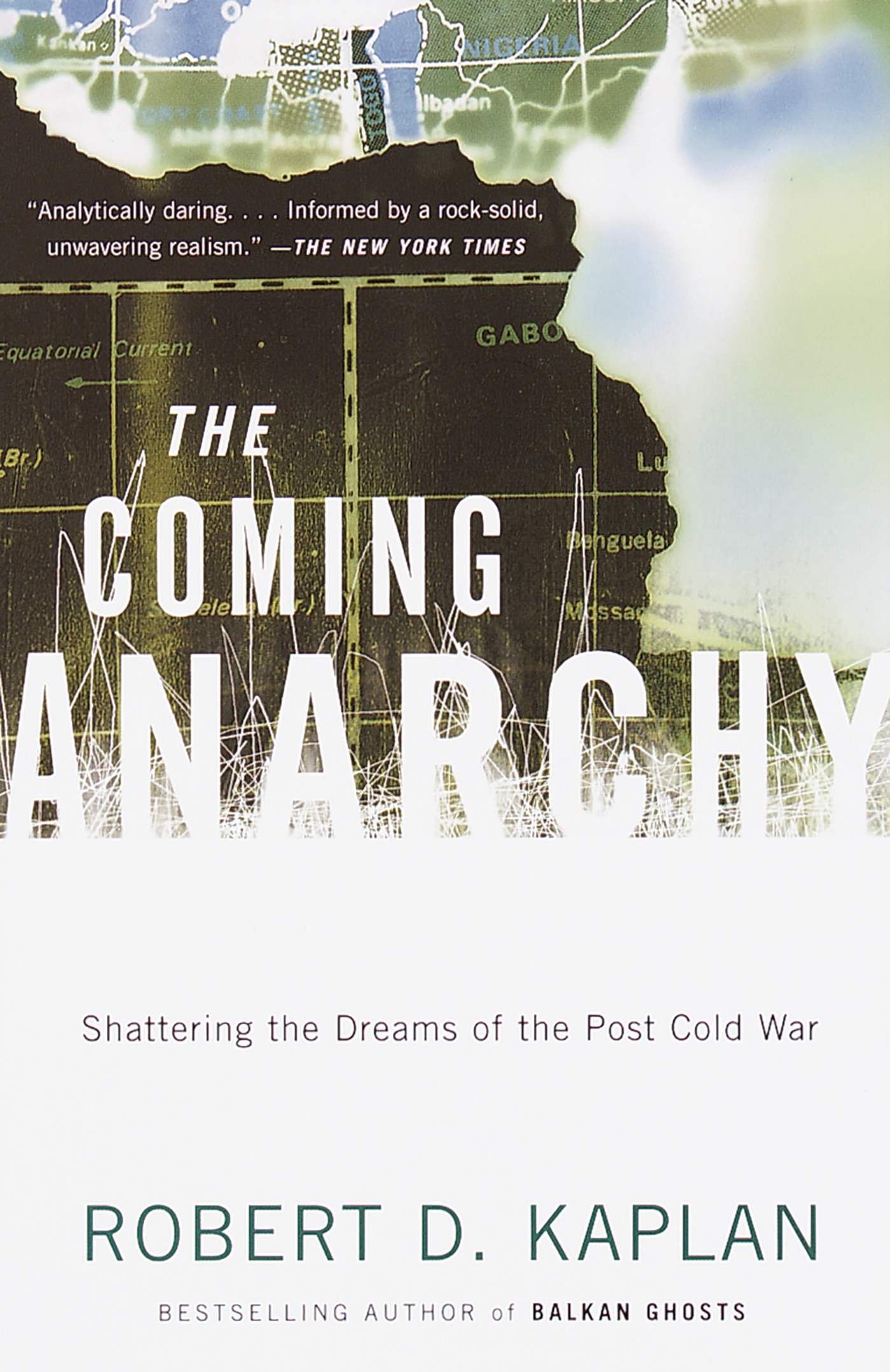
The Coming Anarchy Robert Kaplan, bestselling author of Balkan Ghosts , offers up scrupulous, far-ranging insights on the world to come in a spirited, rousing, and provocative book that has earned a place at the top of the reading lists of the world's policy makers. The end of the Cold War has not ushered in the global peace and prosperity that many had anticipated. Volatile new democracies in Eastern Europe, fierce tribalism in Africa, civil war and ethnic violence in the Near East, and widespread famine and disease—not to mention the brutal rift developing as wealthy nations reap the benefits of seemingly boundless technology while other parts of the world slide into chaos—are among the issues Kaplan identifies as the most important for charting the future of geopolitics. Historical antecedents in Gibbon's Decline and Fall and in the legacies of statesmen such as Henry Kissinger contribute to this bracingly prophetic framework for addressing the new global reality. Bold, erudite, and profoundly important, The Coming Anarchy is a compelling must-read by one of today's most penetrating writers and provocative minds. POLITICAL SCIENCE,International Relations,General

The Clash of Civilizations and the Remaking of World Order The classic study of post-Cold War international relations, more relevant than ever in the post-9/11 world, with a new foreword by Zbigniew Brzezinski. Since its initial publication, The Clash of Civilizations and the Remaking of World Order has become a classic work of international relations and one of the most influential books ever written about foreign affairs. An insightful and powerful analysis of the forces driving global politics, it is as indispensable to our understanding of American foreign policy today as the day it was published. As former National Security Adviser Zbigniew Brzezinski says in his new foreword to the book, it “has earned a place on the shelf of only about a dozen or so truly enduring works that provide the quintessential insights necessary for a broad understanding of world affairs in our time.†Samuel Huntington explains how clashes between civilizations are the greatest threat to world peace but also how an international order based on civilizations is the best safeguard against war. Events since the publication of the book have proved the wisdom of that analysis. The 9/11 attacks and wars in Iraq and Afghanistan have demonstrated the threat of civilizations but have also shown how vital international cross-civilization cooperation is to restoring peace. As ideological distinctions among nations have been replaced by cultural differences, world politics has been reconfigured. Across the globe, new conflicts—and new cooperation—have replaced the old order of the Cold War era. The Clash of Civilizations and the Remaking of World Order explains how the population explosion in Muslim countries and the economic rise of East Asia are changing global politics. These developments challenge Western dominance, promote opposition to supposedly “universal†Western ideals, and intensify intercivilization conflict over such issues as nuclear proliferation, immigration, human rights, and democracy. The Muslim population surge has led to many small wars throughout Eurasia, and the rise of China could lead to a global war of civilizations. Huntington offers a strategy for the West to preserve its unique culture and emphasizes the need for people everywhere to learn to coexist in a complex, multipolar, muliticivilizational world. POLITICAL SCIENCE,International Relations,General
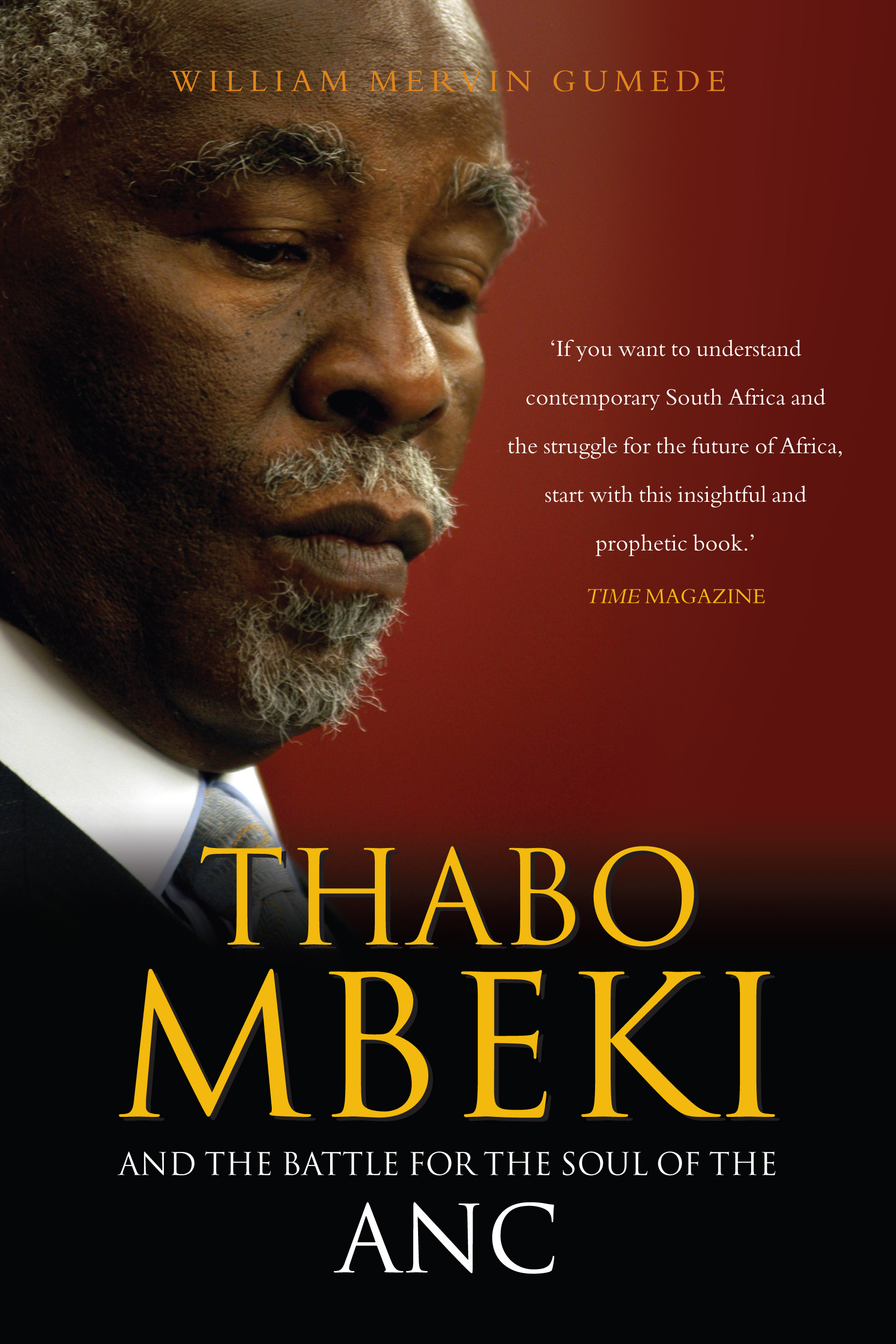
Thabo Mbeki and the Battle for the Soul of the ANC As a spokesman for a country, a continent and the developing world, Thabo Mbeki plays a crucial role in world politics, but to many people he is an enigma. Is this simply because Mbeki is a secretive man, or are there complicated political factors at play?In this book, experienced journalist William Gumede pulls together the insights he has gained from years of reporting on the Mbeki presidency to create a sophisticated but readable account of South Africa's seat of power. He explores the complex position that Mbeki occupies - following in Nelson Mandela's footsteps, heading a party with roots as a liberation movement, and ruling an intensely divided country. Revealing the political and personal tensions behind the scenes, Gumede explains the forces that have created one of the world's most powerful and enigmatic leaders.Covering Mbeki's attempts to modernise the economy and kick-start an African Renaissance, and investigating his controversial stance on issues from AIDS to Zimbabwe, the book offers invaluable insights into the machinations behind political decisions that touch the lives of millions every day. POLITICAL SCIENCE,International Relations,General
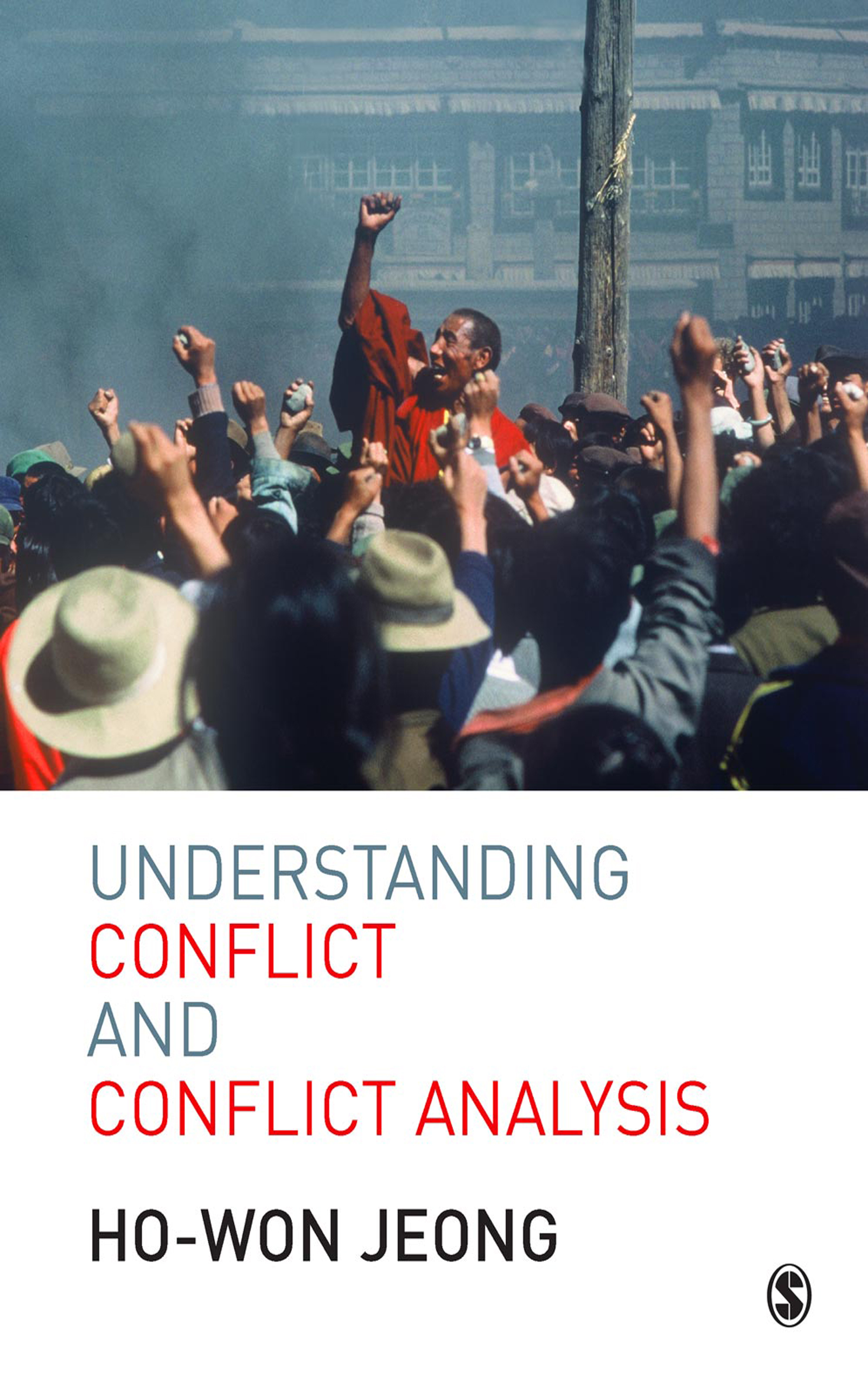
Understanding Conflict and Conflict Analysis An overview of the sources, structure and dynamics of contemporary conflict phenomena, ranging from ethnic and other inter-group conflict to international terrorism and inter-state violence. Jeong helps students acquire the intellectual skills needed for analyzing many different conflict situations themselves. POLITICAL SCIENCE,International Relations,General
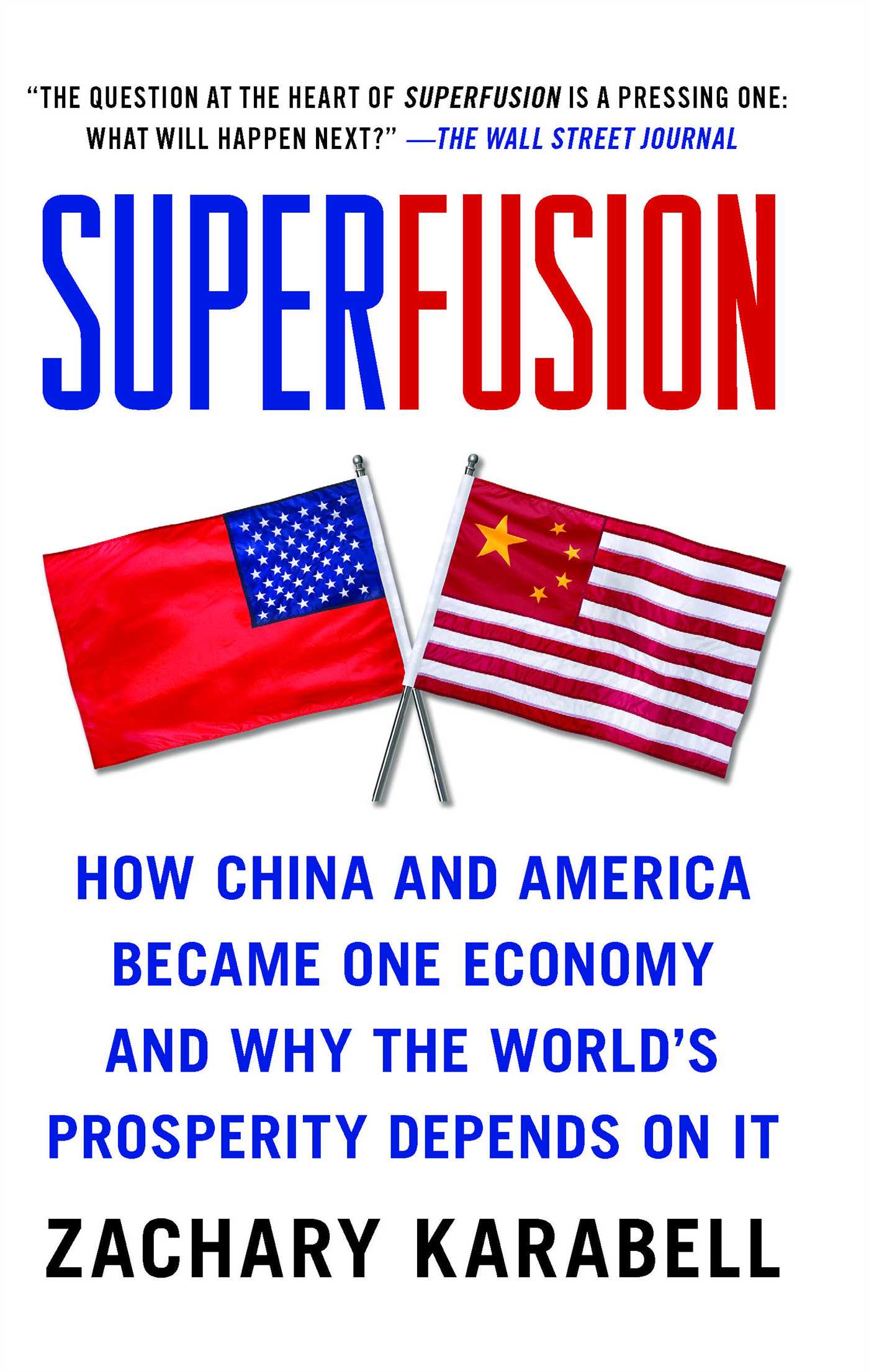
Superfusion Now in paperback, Zachary Karabell argues that the intertwined economic relationship between China and the U.S. will affect our long-term prosperity more than any other contemporary issue. As the world continues the slow work of repairing the damage of the financial crisis, it is crucial that the U.S. understands that it cannot go it alone. Its mutuality with China is permanent, essential, and defining. Zachary Karabell’s brilliant book lays out this complex and important economic story.“Karabell excels at weaving in glitzy tales of the brave new China against the larger backdrop of the Middle Kingdom’s forceful but cautious economic liberalization and the often tortuous, frequently saber-rattling politics of U.S.-China relations….A provocative argument.†—Los Angeles Times “The question at the heart of Superfusion is a pressing one: What will happen next? Mr. Karabell says that the U.S. must turn its thinking away from the military and security challenges of the twentieth century and focus more on the economic challenges of the twenty-first.†—The Wall Street Journal “A compelling brief on the unlikely convergence of the U.S. and Chinese economies….Essential reading for anyone curious about the increasing economic integration and interdependence between China and America, the public opposition in both nations, and the implication for the U.S. as it faces competition from a nation it cannot coerce.†—Publishers Weekly (starred review) POLITICAL SCIENCE,International Relations,General
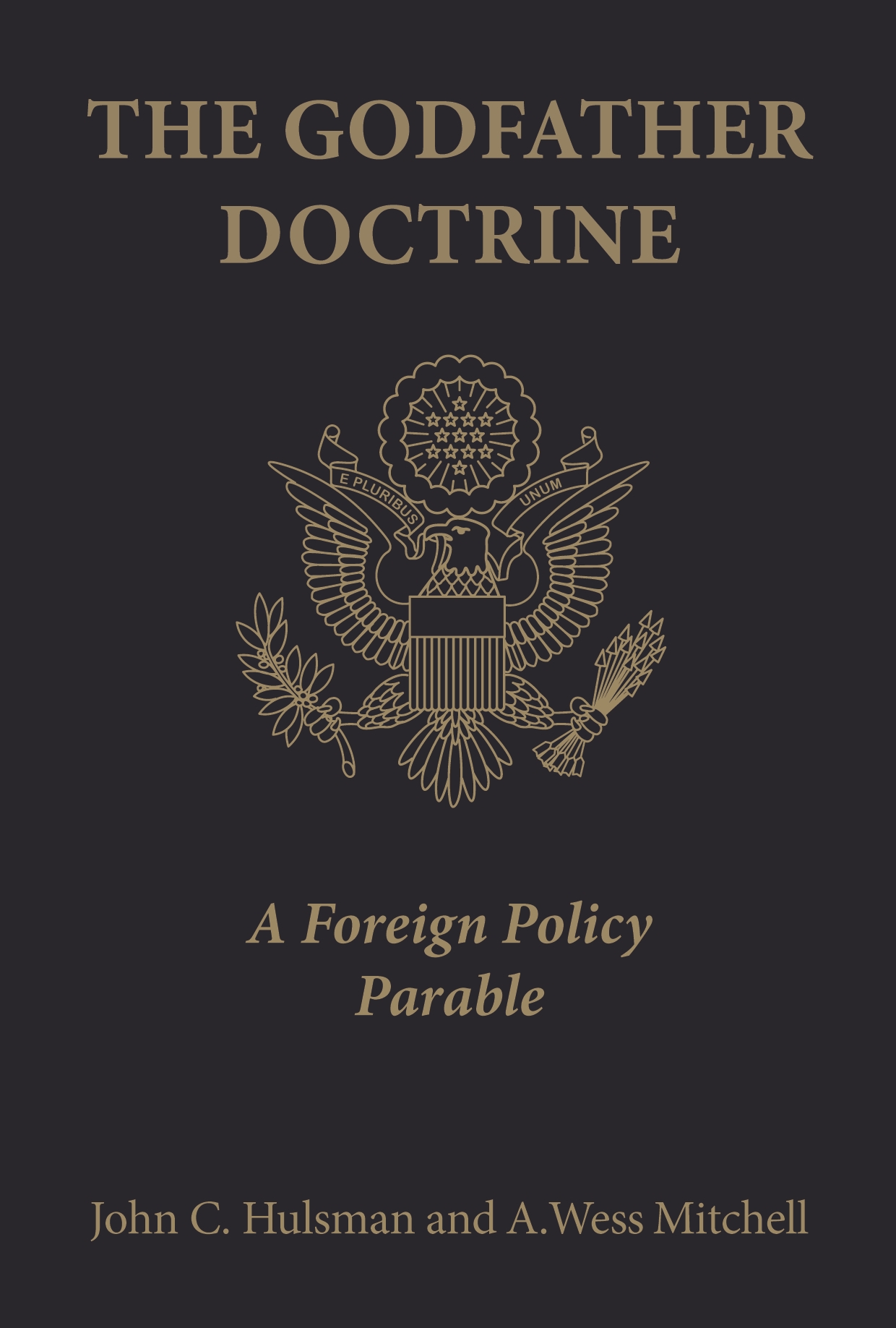
The Godfather Doctrine The Godfather Doctrine draws clear and essential lessons from perhaps the greatest Hollywood movie ever made to illustrate America's changing geopolitical place in the world and how our country can best meet the momentous strategic challenges it faces. In the movie The Godfather, Don Corleone, head of New York's most powerful organized-crime family, is shockingly gunned down in broad daylight, leaving his sons Sonny and Michael, along with his adopted son, consigliere Tom Hagen, to chart a new course for the family. In The Godfather Doctrine, John Hulsman and Wess Mitchell show how the aging and wounded don is emblematic of cold-war American power on the decline in a new world where our enemies play by unfamiliar rules, and how the don's heirs uncannily exemplify the three leading schools of American foreign policy today. Tom, the left-of-center liberal institutionalist, thinks the old rules still apply and that negotiation is the answer. Sonny is the Bush-era neocon who shoots first and asks questions later, proving an easy target for his enemies. Only Michael, the realist, has a sure feel for the changing scene, recognizing the need for flexible combinations of soft and hard power to keep the family strong and maintain its influence and security in a dangerous and rapidly changing world. Based on Hulsman and Mitchell's groundbreaking and widely debated article, "Pax Corleone," The Godfather Doctrine explains for everyone why Francis Ford Coppola's epic story about a Mafia dynasty holds key insights for ensuring America's survival in the twenty-first century. POLITICAL SCIENCE,International Relations,General
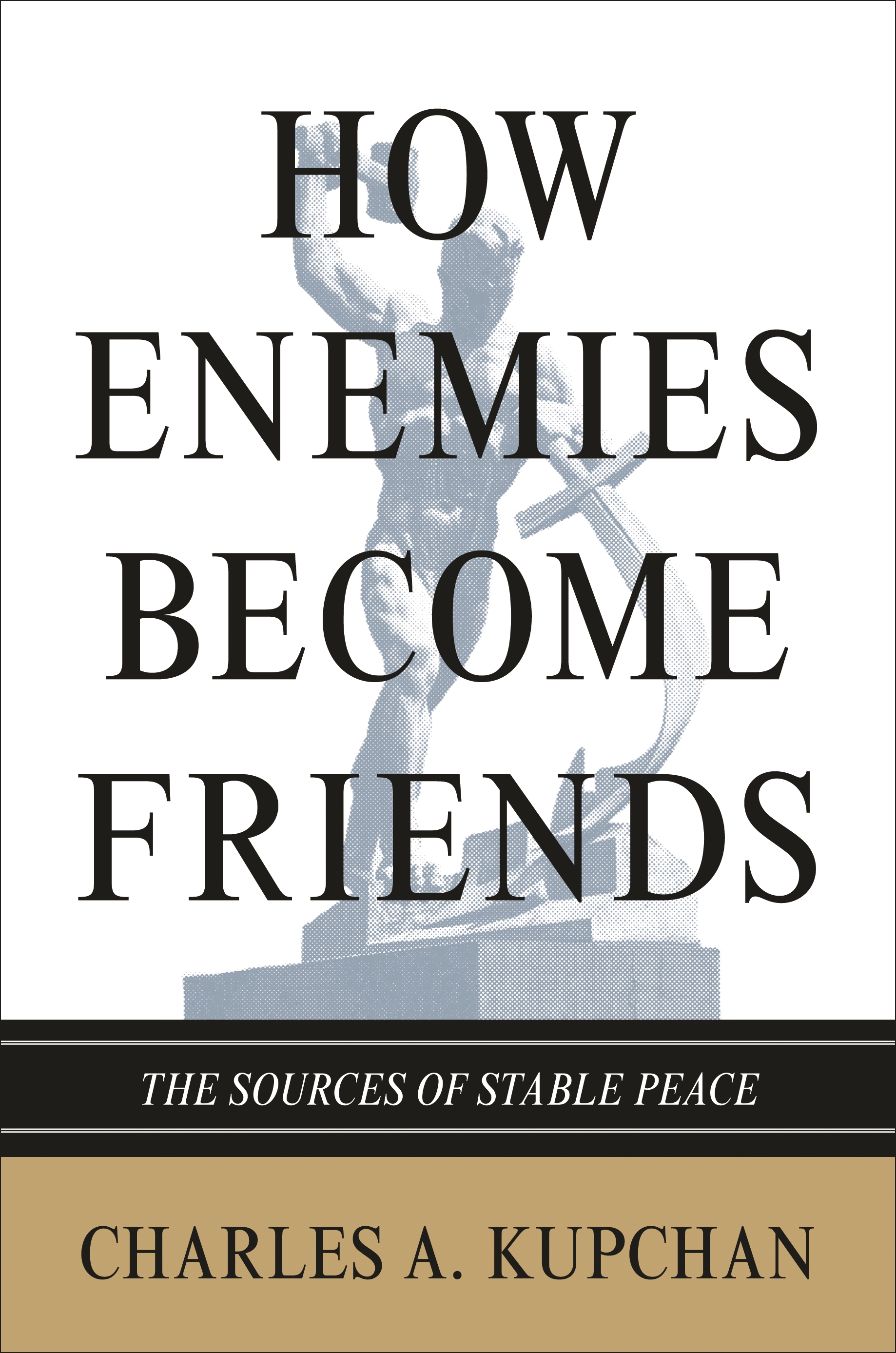
How Enemies Become Friends How nations move from war to peace Is the world destined to suffer endless cycles of conflict and war? Can rival nations become partners and establish a lasting and stable peace? How Enemies Become Friends provides a bold and innovative account of how nations escape geopolitical competition and replace hostility with friendship. Through compelling analysis and rich historical examples that span the globe and range from the thirteenth century through the present, foreign policy expert Charles Kupchan explores how adversaries can transform enmity into amity—and he exposes prevalent myths about the causes of peace. Kupchan contends that diplomatic engagement with rivals, far from being appeasement, is critical to rapprochement between adversaries. Diplomacy, not economic interdependence, is the currency of peace; concessions and strategic accommodation promote the mutual trust needed to build an international society. The nature of regimes matters much less than commonly thought: countries, including the United States, should deal with other states based on their foreign policy behavior rather than on whether they are democracies. Kupchan demonstrates that similar social orders and similar ethnicities, races, or religions help nations achieve stable peace. He considers many historical successes and failures, including the onset of friendship between the United States and Great Britain in the early twentieth century, the Concert of Europe, which preserved peace after 1815 but collapsed following revolutions in 1848, and the remarkably close partnership of the Soviet Union and China in the 1950s, which descended into open rivalry by the 1960s. In a world where conflict among nations seems inescapable, How Enemies Become Friends offers critical insights for building lasting peace. POLITICAL SCIENCE,International Relations,General
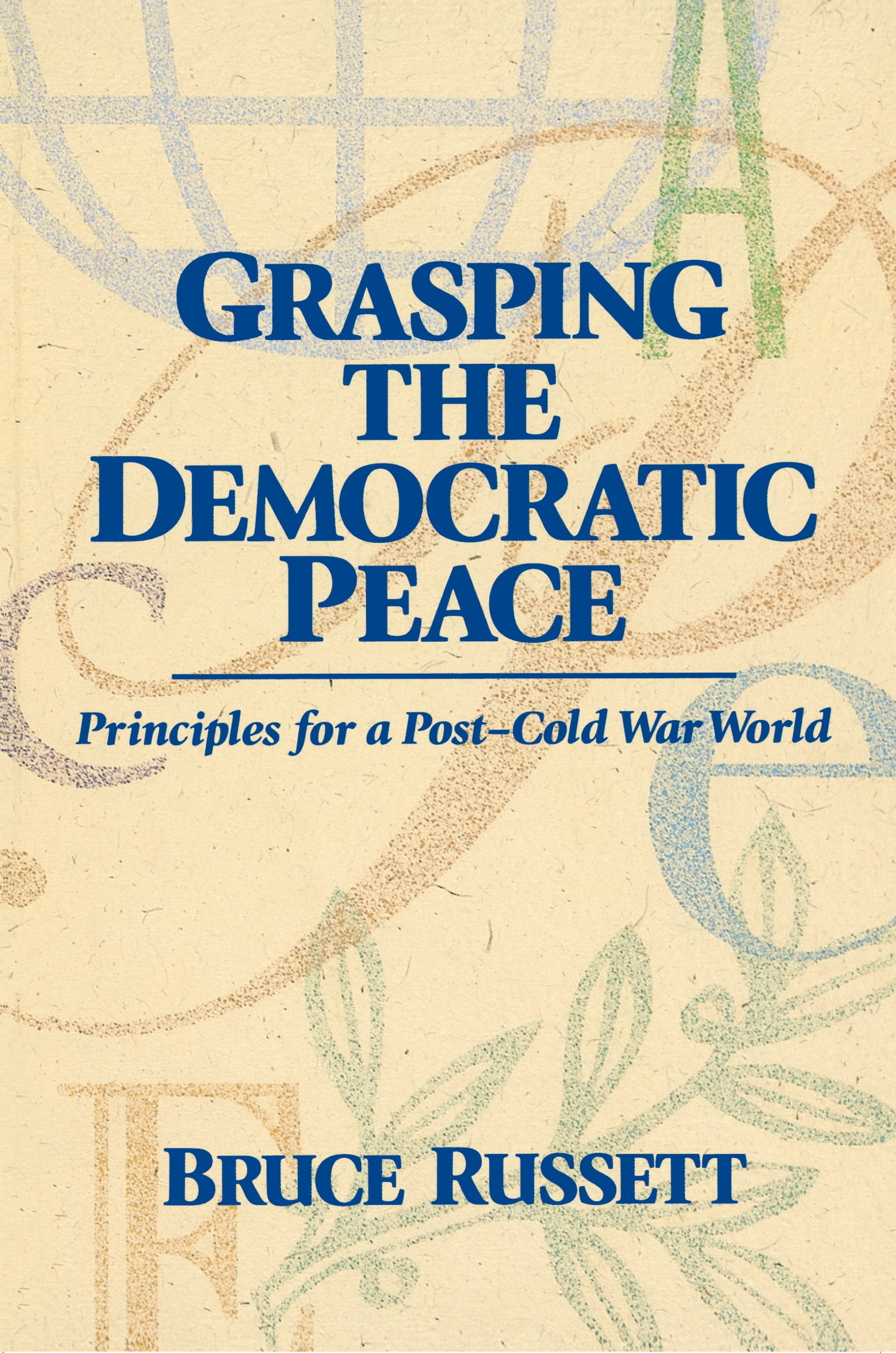
Grasping the Democratic Peace By illuminating the conflict-resolving mechanisms inherent in the relationships between democracies, Bruce Russett explains one of the most promising developments of the modern international system: the striking fact that the democracies that it comprises have almost never fought each other. POLITICAL SCIENCE,International Relations,General

Engaging the Enemy Did a "doctrine race" exist alongside the much-publicized arms competition between East and West? Using recent insights from organization theory, Kimberly Marten Zisk answers this question in the affirmative. Zisk challenges the standard portrayal of Soviet military officers as bureaucratic actors wedded to the status quo: she maintains that when they were confronted by a changing external security environment, they reacted by producing innovative doctrine. The author's extensive evidence is drawn from newly declassified Soviet military journals, and from her interviews with retired high-ranking Soviet General Staff officers and highly placed Soviet-Russian civilian defense experts. According to Zisk, the Cold War in Europe was powerfully influenced by the reactions of Soviet military officers and civilian defense experts to modifications in U.S. and NATO military doctrine. Zisk also asserts that, contrary to the expectations of many analysts, civilian intervention in military policy-making need not provoke pitched civil-military conflict. Under Gorbachev's leadership, for instance, great efforts were made to ensure that "defensive defense" policies reflected military officers' input and expertise. Engaging the Enemy makes an important contribution not only to the theory of military organizations and the history of Soviet military policy but also to current policy debates on East-West security issues. Kimberly Marten Zisk is Assistant Professor of Political Science and Faculty Associate of the Mershon Center at the Ohio State University. POLITICAL SCIENCE,International Relations,General

The Tiger Vanquished This book tells the story of why the Liberation Tigers of Tamil Eelam (LTTE) lost the war that it had always dreamt of winning in Sri Lanka. It is a collection of news stories and commentaries penned by the author from 2003 to 2009 on the ethnic conflict in the country. Each piece is provided with an introduction that places it in the context in which it was written. The unfolding of the drama is brought about through conversations with Sri Lankan leaders, Tamil activists, Indian officials, Norwegian and other diplomats, human rights activists, former LTTE guerrillas, and civilians. POLITICAL SCIENCE,International Relations,General
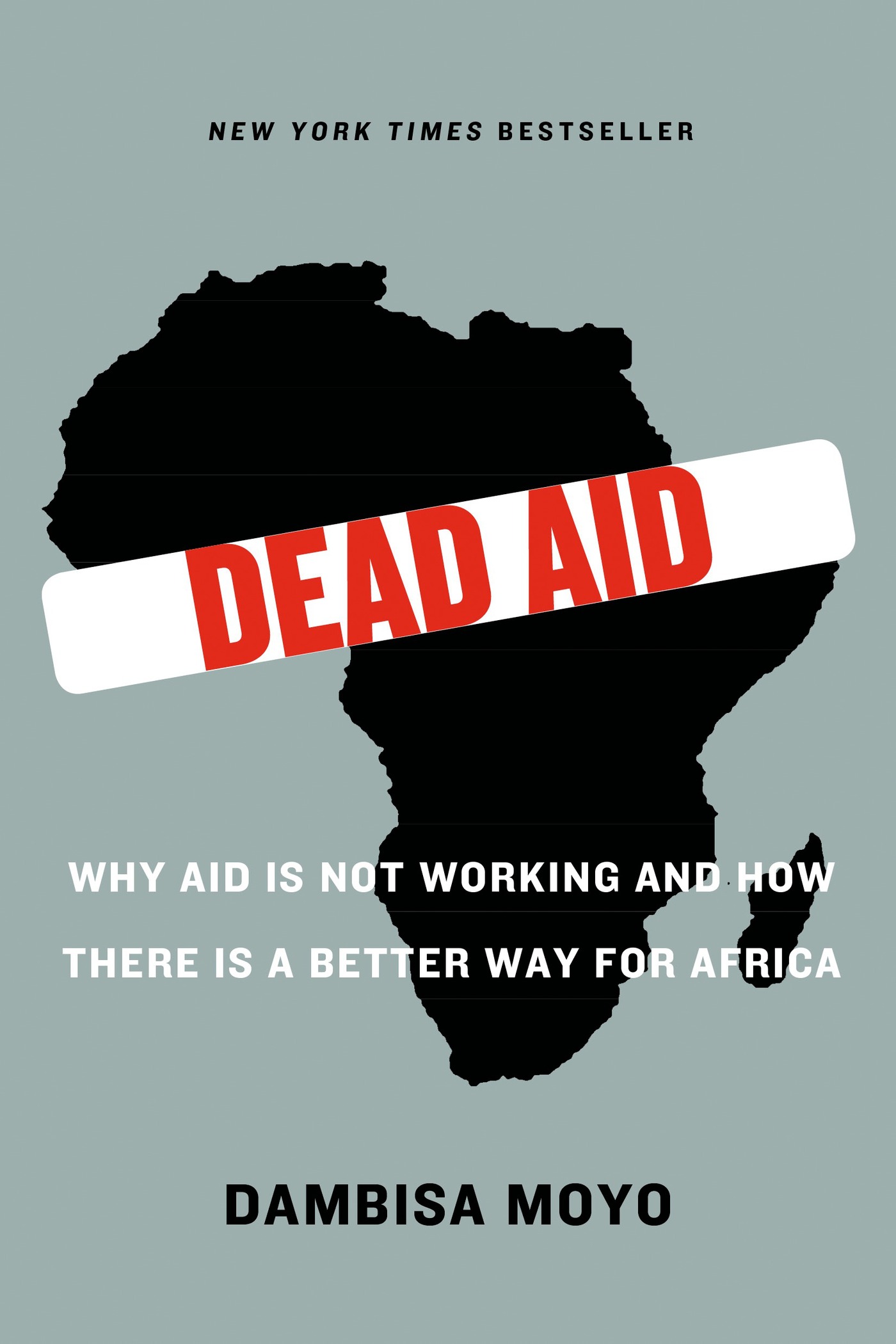
Dead Aid In the past fifty years, more than $1 trillion in development-related aid has been transferred from rich countries to Africa. Has this assistance improved the lives of Africans? No. In fact, across the continent, the recipients of this aid are not better off as a result of it, but worse—much worse. In Dead Aid, Dambisa Moyo describes the state of postwar development policy in Africa today and unflinchingly confronts one of the greatest myths of our time: that billions of dollars in aid sent from wealthy countries to developing African nations has helped to reduce poverty and increase growth. In fact, poverty levels continue to escalate and growth rates have steadily declined—and millions continue to suffer. Provocatively drawing a sharp contrast between African countries that have rejected the aid route and prospered and others that have become aid-dependent and seen poverty increase, Moyo illuminates the way in which overreliance on aid has trapped developing nations in a vicious circle of aid dependency, corruption, market distortion, and further poverty, leaving them with nothing but the "need" for more aid. Debunking the current model of international aid promoted by both Hollywood celebrities and policy makers, Moyo offers a bold new road map for financing development of the world's poorest countries that guarantees economic growth and a significant decline in poverty—without reliance on foreign aid or aid-related assistance. Dead Aid is an unsettling yet optimistic work, a powerful challenge to the assumptions and arguments that support a profoundly misguided development policy in Africa. And it is a clarion call to a new, more hopeful vision of how to address the desperate poverty that plagues millions. POLITICAL SCIENCE,International Relations,General

British Foreign Policy, National Identity, and Neoclassical Realism This groundbreaking study offers a genuinely multidisciplinary exploration of cultural influences on foreign policy. Through an innovative blend of historical analysis, neoclassical realist theory, and cultural studies, Amelia Hadfield-Amkhan shows how national identity has been a catalyst for British foreign policy decisions, helping the state to both define and defend itself. Representing key points of crisis, her case studies include the 1882 attempt to construct a tunnel to France, the 1982 Falklands War, and the 2003 decision to remain outside the Eurozone. The author argues that these events, marking the decline of a great power, have forced Britain into periods of deep self-reflection that are carved into its culture and etched into its policy stances on central issues of sovereignty, territorial integrity, international recognition, and even monetary policy. POLITICAL SCIENCE,International Relations,General
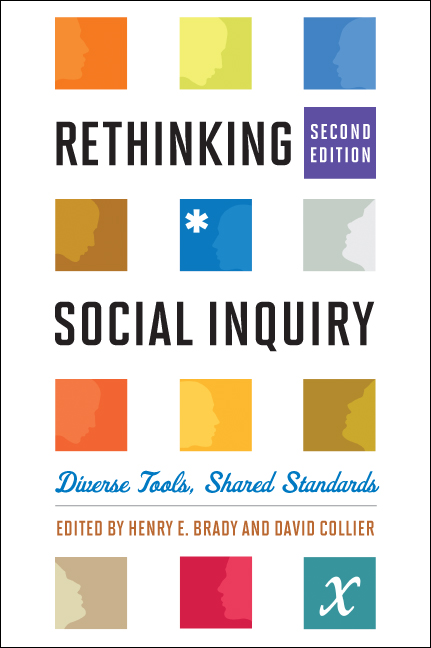
Rethinking Social Inquiry With innovative new chapters on process tracing, regression analysis, and natural experiments, the second edition of Rethinking Social Inquiry further extends the reach of this path-breaking book. The original debate with King, Keohane, and Verba_now updated_remains central to the volume, and the new material illuminates evolving discussions of essential methodological tools. Thus, process tracing is often invoked as fundamental to qualitative analysis, but is rarely applied with precision. Pitfalls of regression analysis are sometimes noted, but often are inadequately examined. And the complex assumptions and trade-offs of natural experiments are poorly understood. The second edition extends the methodological horizon through exploring these critical tools. A distinctive feature of this edition is the online placement of four chapters from the prior edition, all focused on the dialogue with King, Keohane, and Verba. Also posted online are exercises for teaching process tracing. POLITICAL SCIENCE,International Relations,General

From Beirut to Jerusalem This revised edition of the number-one bestseller and winner of the 1989 National Book Award includes the Pulitzer Prize-winning author's new, updated epilogue. One of the most thought-provoking books ever written about the Middle East, From Beirut to Jerusalem remains vital to our understanding of this complex and volatile region of the world. Three-time Pulitzer Prize winner Thomas L. Friedman drew upon his ten years of experience reporting from Lebanon and Israel to write this now-classic work of journalism. In a new afterword, he updates his journey with a fresh discussion of the Arab Awakenings and how they are transforming the area, and a new look at relations between Israelis and Palestinians, and Israelis and Israelis. Rich with anecdote, history, analysis, and autobiography, From Beirut to Jerusalem will continue to shape how we see the Middle East for many years to come. "If you're only going to read one book on the Middle East, this is it."--Seymour M. Hersh POLITICAL SCIENCE,International Relations,General
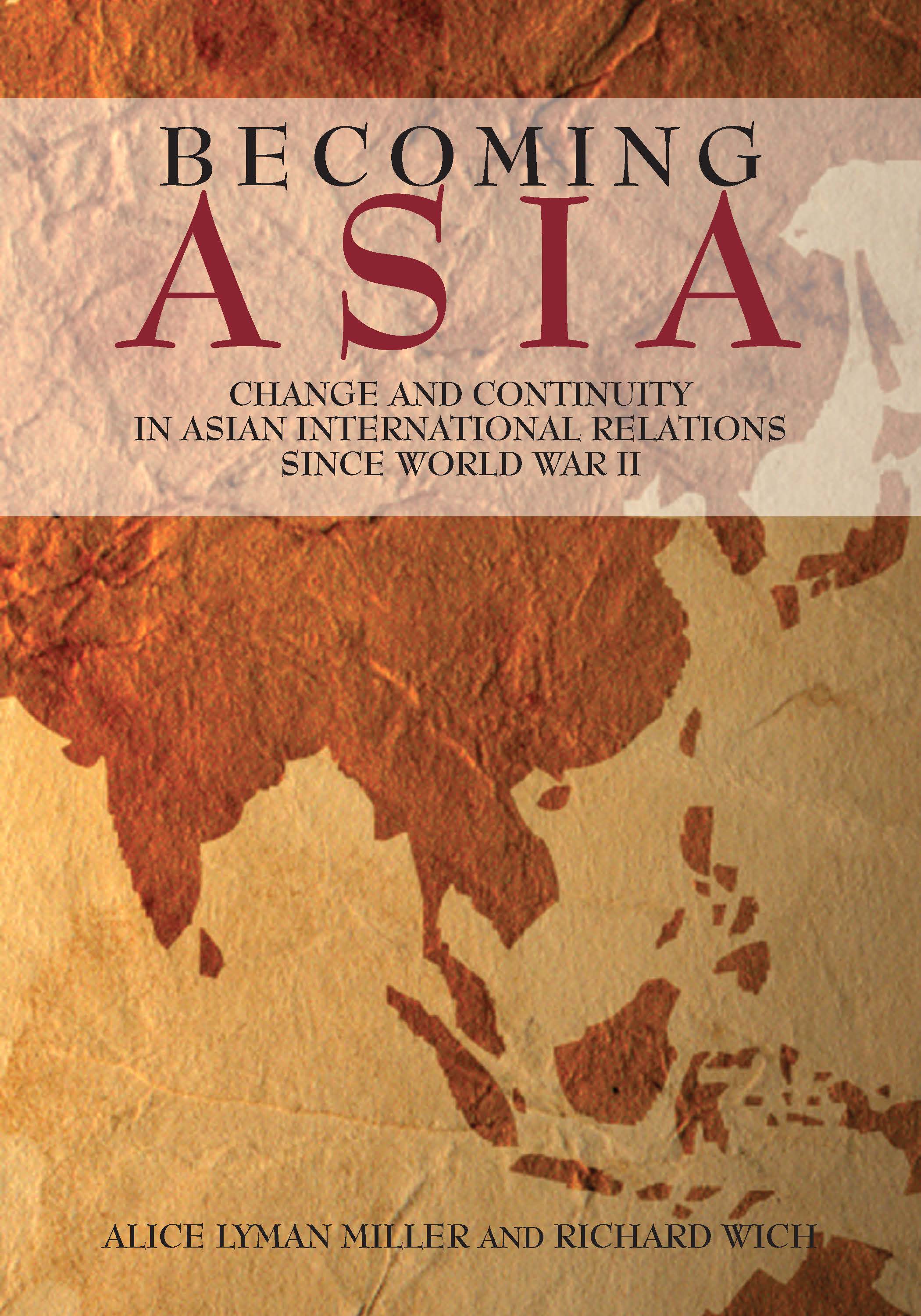
Becoming Asia This student-friendly text details the fascinating history of how Asia has evolved from being little more than a geographic expression to becoming a vibrant, assertive region with an increasing impact on global political, economic, and security affairs. POLITICAL SCIENCE,International Relations,General
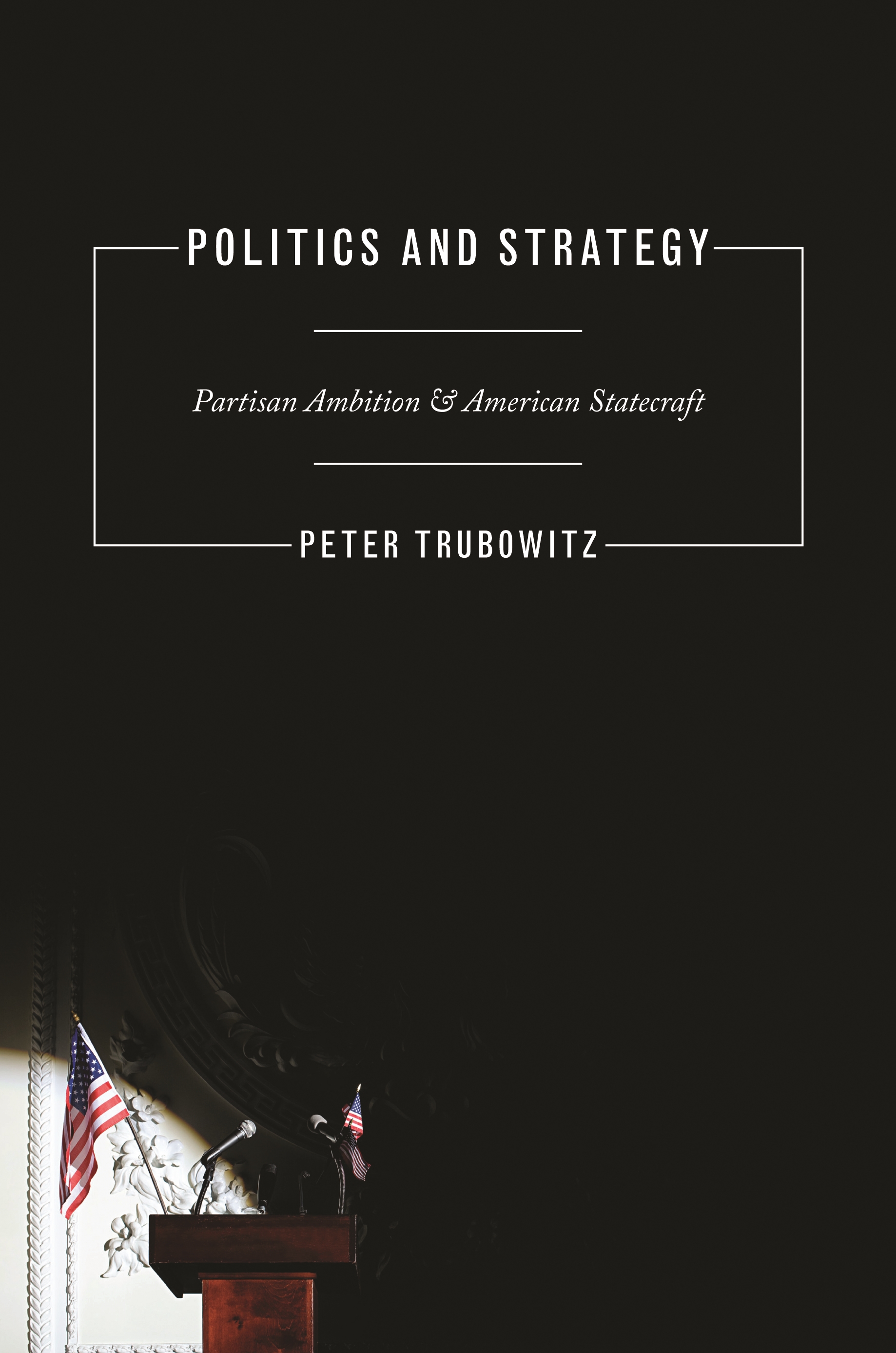
Politics and Strategy Why do some national leaders pursue ambitious grand strategies and adventuresome foreign policies while others do not? When do leaders boldly confront foreign threats and when are they less assertive? Politics and Strategy shows that grand strategies are Janus-faced: their formulation has as much to do with a leader's ability to govern at home as it does with maintaining the nation's security abroad. Drawing on the American political experience, Peter Trubowitz reveals how variations in domestic party politics and international power have led presidents from George Washington to Barack Obama to pursue strategies that differ widely in international ambition and cost. He considers why some presidents overreach in foreign affairs while others fail to do enough. Trubowitz pushes the understanding of grand strategy beyond traditional approaches that stress only international forces or domestic interests. He provides insights into how past leaders responded to cross-pressures between geopolitics and party politics, and how similar issues continue to bedevil American statecraft today. He suggests that the trade-offs shaping American leaders' foreign policy choices are not unique--analogous trade-offs confront Chinese and Russian leaders as well. Combining innovative theory and historical analysis, Politics and Strategy answers classic questions of statecraft and offers new ideas for thinking about grand strategies and the leaders who make them. POLITICAL SCIENCE,International Relations,General
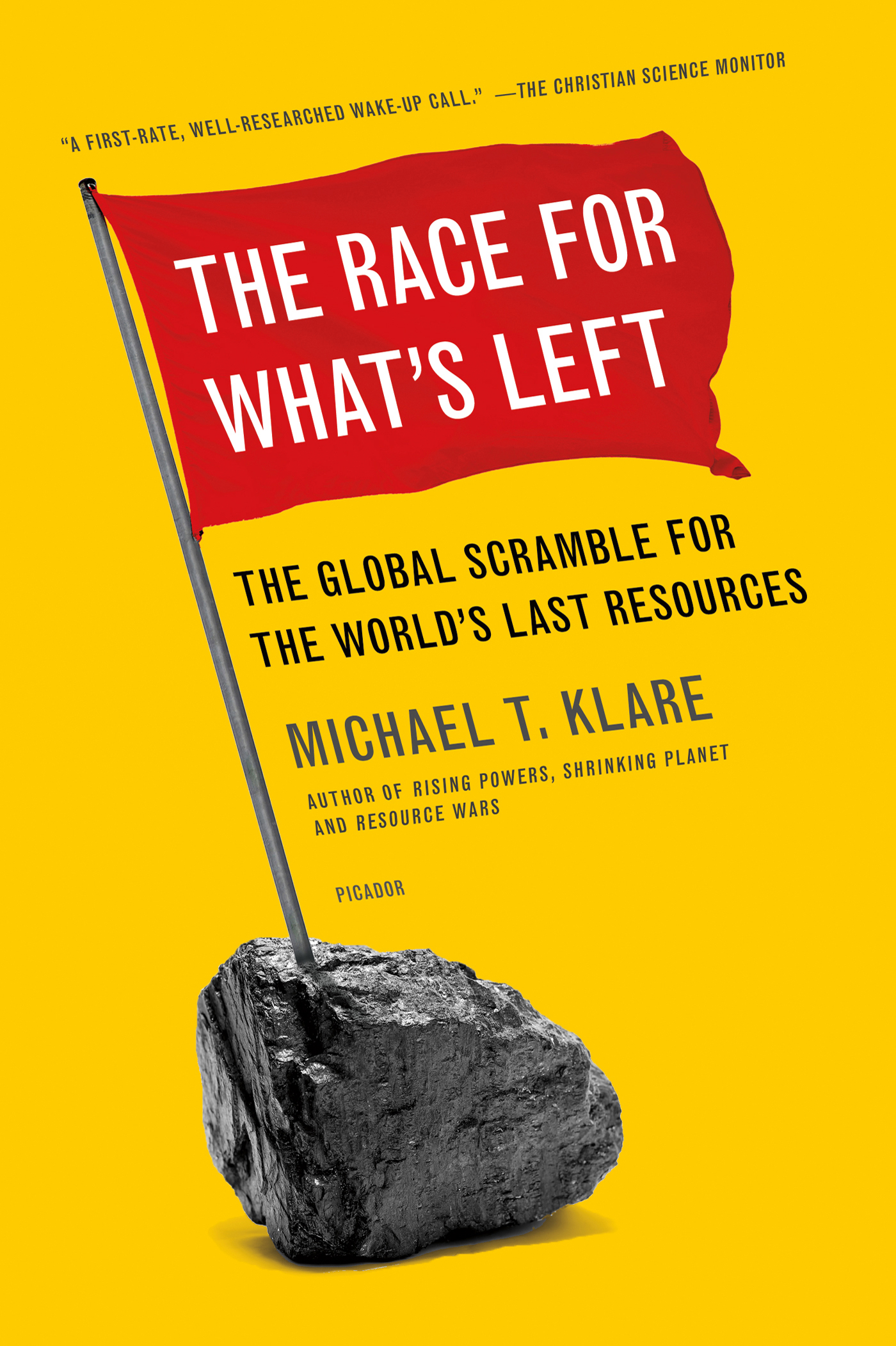
The Race for What's Left From Michael Klare, the renowned expert on natural resource issues, an invaluable account of a new and dangerous global competition The world is facing an unprecedented crisis of resource depletion—a crisis that goes beyond "peak oil" to encompass shortages of coal and uranium, copper and lithium, water and arable land. With all of the planet's easily accessible resource deposits rapidly approaching exhaustion, the desperate hunt for supplies has become a frenzy of extreme exploration, as governments and corporations rush to stake their claim in areas previously considered too dangerous and remote. The Race for What's Left takes us from the Arctic to war zones to deep ocean floors, from a Russian submarine planting the country's flag on the North Pole seabed to the large-scale buying up of African farmland by Saudi Arabia, China, and other food-importing nations. As Klare explains, this invasion of the final frontiers carries grave consequences. With resource extraction growing more complex, the environmental risks are becoming increasingly severe; the Deepwater Horizon disaster is only a preview of the dangers to come. At the same time, the intense search for dwindling supplies is igniting new border disputes, raising the likelihood of military confrontation. Inevitably, if the scouring of the globe continues on its present path, many key resources that modern industry relies upon will disappear completely. The only way out, Klare argues, is to alter our consumption patterns altogether—a crucial task that will be the greatest challenge of the coming century. POLITICAL SCIENCE,International Relations,General
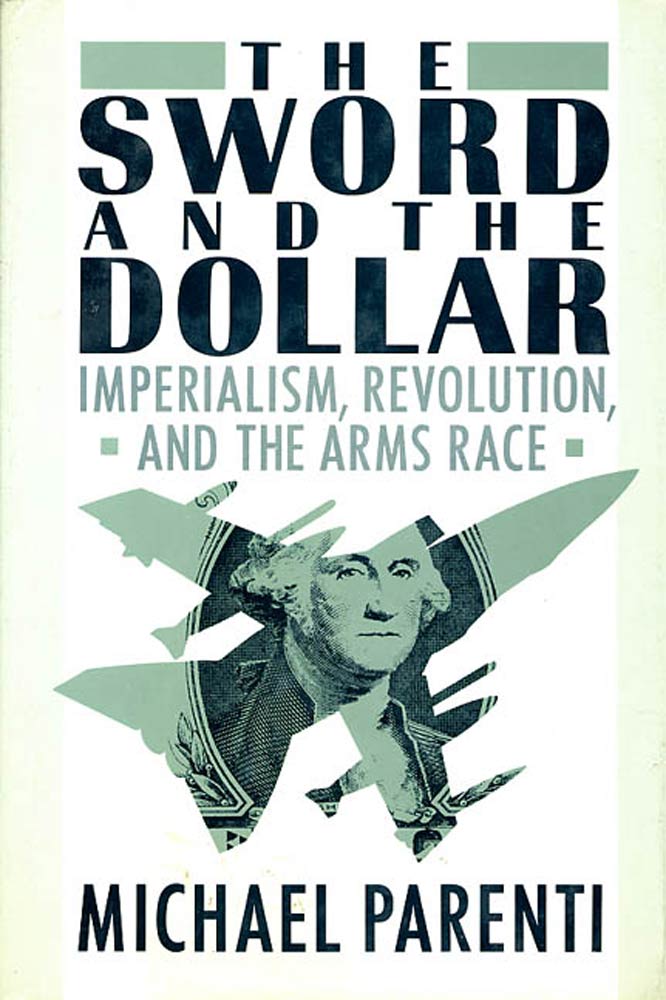
The Sword & The Dollar To many, the foreign policy directives of the United States seem bewildering and sometimes inharmonious with its domestic political values. Why does the U.S. seem to support foreign dictators? Why has it invested so many of its resources in stockpiling nuclear arms? Why doesn't the U.S. act as a force for peace throughout the world? In this probing, provocative analysis, Michael Parenti reveals the hidden agenda of American foreign policy decsisions. No matter which party is in power, the U.S. acts to protect the interests of large American-based corporations, in order to maintain valuable overseas markets and cheap foreign labor. In lucid detail, Michael Parenti examines just how these very private interests determine America's public policy goals, from the impoverishment of developing nations to the building of an intimidating nuclear arsenal. What he discovers will surely be controversial and suggests that the greatest threats to democracy—both here and abroad—may emanate from within the United States itself. POLITICAL SCIENCE,International Relations,General
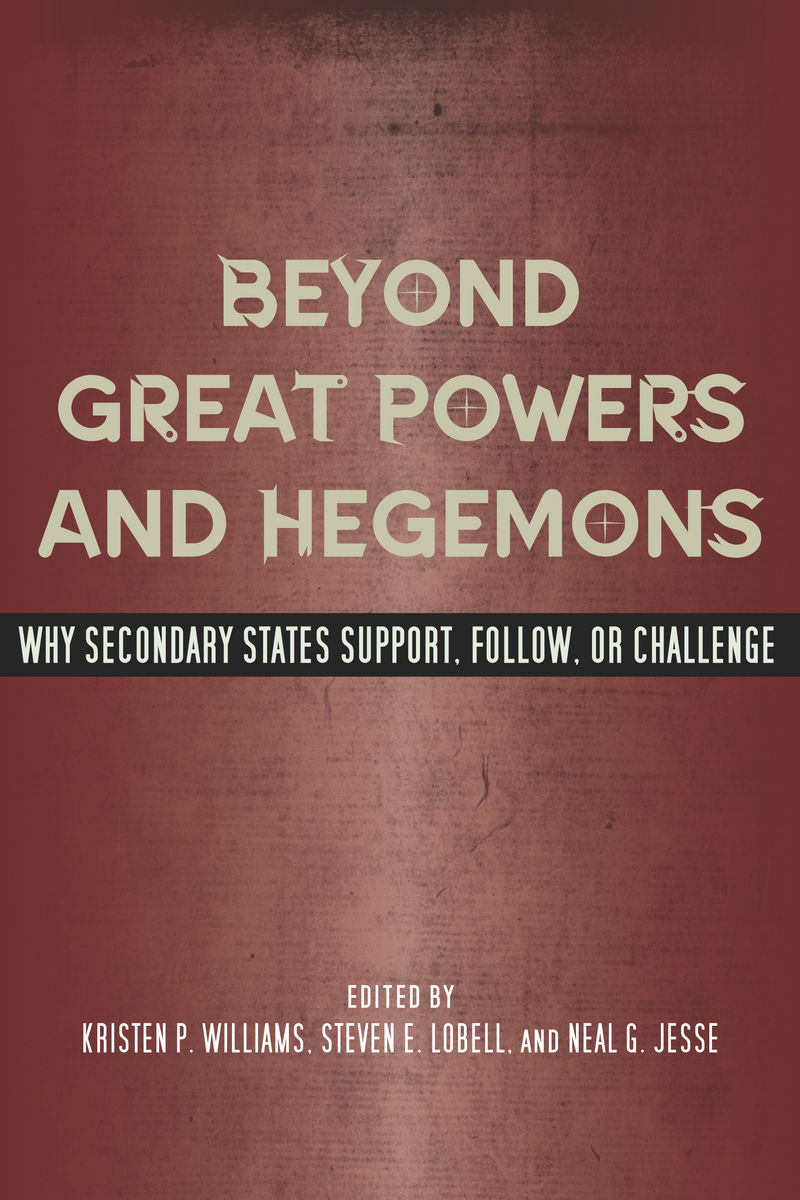
Beyond Great Powers and Hegemons This book provides frameworks and case studies examining the interests, motivations, objectives, and strategies of smaller states in response to a regional or global hegemon. POLITICAL SCIENCE,International Relations,General

Expelled In 2007 Luke Harding arrived in Moscow to take up a new job as a correspondent for the British newspaper, The Guardian. Within months, mysterious agents from Russia's Federal Security Service --the successor to the KGB--had broken into his apartment. He found himself tailed by men in leather jackets, bugged, and even summoned to the KGB's notorious prison, Lefortovo. The break-in was the beginning of an extraordinary psychological war against the journalist and his family. Windows left open in his children's bedroom, secret police agents tailing Harding on the street, and customs agents harassing the family as they left and entered the country became the norm. The campaign of persecution burst into the open in 2011 when the Kremlin expelled Harding from Moscow--the first western reporter to be deported from Russia since the days of the Cold War. Expelled is a brilliant and haunting account of the insidious methods used by a resurgent Kremlin against its so-called "enemies"--human rights workers, western diplomats, journalists and opposition activists. It includes illuminating diplomatic cables which describe Russia as a "virtual mafia state". Harding gives a personal and compelling portrait of Russia that--in its bid to remain a superpower--is descending into a corrupt police state. POLITICAL SCIENCE,International Relations,General
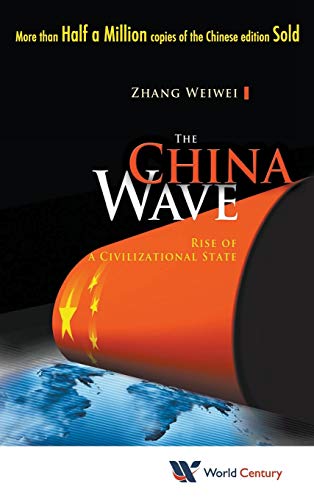
China Wave, The This is a best-seller in China and a geopolitical book for our times. As a leading thinker from China, Zhang Weiwei provides an original, comprehensive and engrossing study on the rise of China and its effective yet controversial model of development, and the book has become a centerpiece of an unfolding debate within China on the nature and future of the world's most populous nation and its possible global impact. China's rise, according to Zhang, is not the rise of an ordinary country, but the rise of a different type of country, a country sui generis, a civilizational state, a new model of development and a new political discourse which indeed questions many of the Western assumptions about democracy, good governance and human rights. The book is as analytical as it is provocative, and should be required reading for everyone concerned with the rise of China and its global implications. POLITICAL SCIENCE,International Relations,General

Special Providence From one of our leading experts on foreign policy, a full-scale reinterpretation of America’s dealings—from its earliest days—with the rest of the world. It is Walter Russell Mead’s thesis that the United States, by any standard, has had a more successful foreign policy than any of the other great powers that we have faced—and faced down. Beginning as an isolated string of settlements at the edge of the known world, this country—in two centuries—drove the French and the Spanish out of North America; forced Britain, then the world’s greatest empire, to respect American interests; dominated coalitions that defeated German and Japanese bids for world power; replaced the tottering British Empire with a more flexible and dynamic global system built on American power; triumphed in the Cold War; and exported its language, culture, currency, and political values throughout the world. Yet despite, and often because of, this success, both Americans and foreigners over the decades have routinely considered American foreign policy to be amateurish and blundering, a political backwater and an intellectual wasteland. Now, in this provocative study, Mead revisits our history to counter these appraisals. He attributes this unprecedented success (as well as recurring problems) to the interplay of four schools of thought, each with deep roots in domestic politics and each characterized by a central focus or concern, that have shaped our foreign policy debates since the American Revolution—the Hamiltonian: the protection of commerce; the Jef-fersonian: the maintenance of our democratic system; the Jacksonian: populist values and military might; and the Wilsonian: moral principle. And he delineates the ways in which they have continually, and for the most part beneficially, informed the intellectual and political bases of our success as a world power. These four schools, says Mead, are as vital today as they were two hundred years ago, and they can and should guide the nation through the challenges ahead. Special Providence is a brilliant analysis, certain to influence the way America thinks about its national past, its future, and the rest of the world. POLITICAL SCIENCE,International Relations,General

Overbooked Tourism, fast becoming the largest global business, employs one out of twelve persons and produces $6.5 trillion of the world’s economy. In a groundbreaking book, Elizabeth Becker uncovers how what was once a hobby has become a colossal enterprise with profound impact on countries, the environment, and cultural heritage. This invisible industry exploded at the end of the Cold War. In 2012 the number of tourists traveling the world reached one billion. Now everything can be packaged as a tour: with the high cost of medical care in the U.S., Americans are booking a vacation and an operation in countries like Turkey for a fraction of the cost at home. Becker travels the world to take the measure of the business: France invented the travel business and is still its leader; Venice is expiring of over-tourism. In Cambodia, tourists crawl over the temples of Angkor, jeopardizing precious cultural sites. Costa Rica rejected raising cattle for American fast-food restaurants to protect their wilderness for the more lucrative field of eco-tourism. Dubai has transformed a patch of desert in the Arabian Gulf into a mammoth shopping mall. Africa’s safaris are thriving, even as its wildlife is threatened by foreign poachers. Large cruise ships are spoiling the oceans and ruining city ports as their American-based companies reap handsome profits through tax loopholes. China, the giant, is at last inviting tourists and sending its own out in droves. The United States, which invented some of the best of tourism, has lost its edge due to political battles. Becker reveals travel as product. Seeing the tourism industry from the inside out, through her eyes and ears, we experience a dizzying range of travel options though very few quiet getaways. Her investigation is a first examination of one of the largest and potentially most destructive enterprises in the world. POLITICAL SCIENCE,International Relations,General
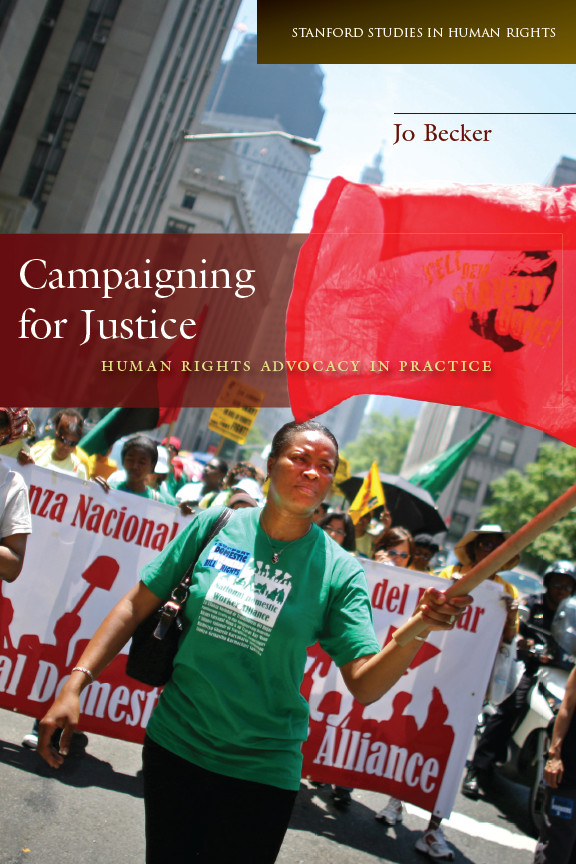
Campaigning for Justice Explores the strategies behind some of the most innovative human rights campaigns and exciting human rights victories of recent years. POLITICAL SCIENCE,International Relations,General
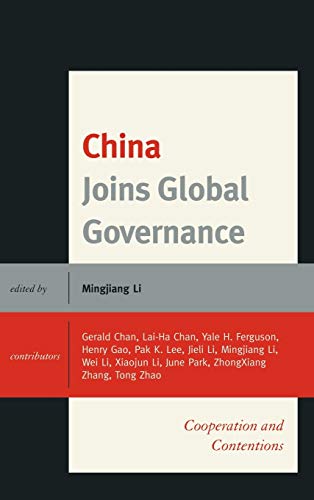
China Joins Global Governance China Joins Global Governance: Cooperation and Contentions , edited by Mingjiang Li, provides a comprehensive and insightful examination of China’s role in global governance. The contributors make a significant contribution to the scholarly debate on the impacts of China’s rise on the stability and future evolution of the international system. POLITICAL SCIENCE,International Relations,General

Handbook of International Relations The eagerly-awaited new edition of the ground-breaking Handbook of International Relations , edited by three of the leading scholars in the field. POLITICAL SCIENCE,International Relations,General
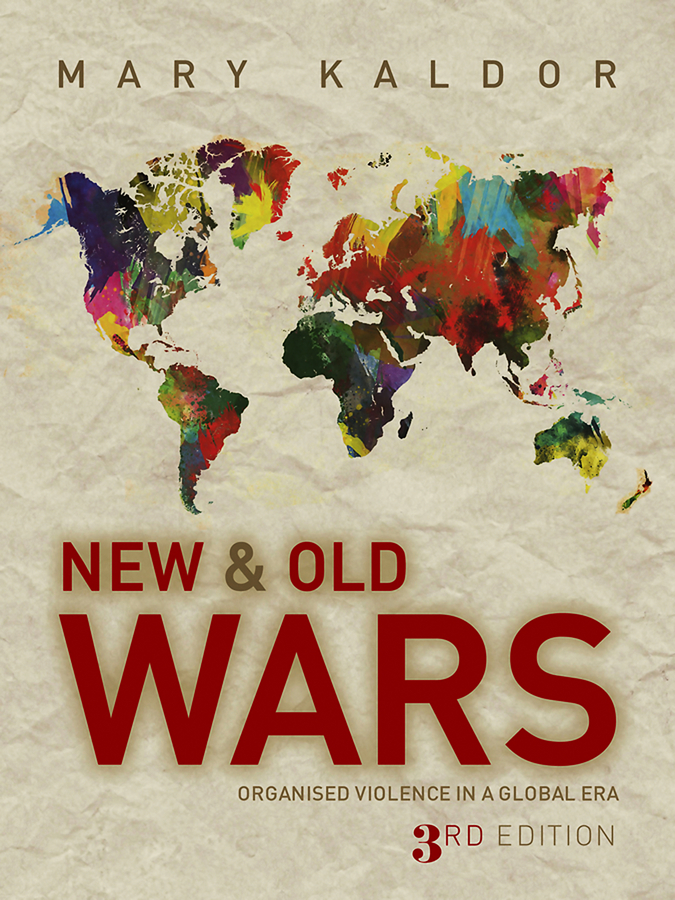
New and Old Wars Mary Kaldor's New and Old Wars has fundamentally changed the way both scholars and policy-makers understand contemporary war and conflict. In the context of globalization, this path-breaking book has shown that what we think of as war - that is to say, war between states in which the aim is to inflict maximum violence - is becoming an anachronism. In its place is a new type of organized violence or 'new wars', which could be described as a mixture of war, organized crime and massive violations of human rights. The actors are both global and local, public and private. The wars are fought for particularistic political goals using tactics of terror and destabilization that are theoretically outlawed by the rules of modern warfare. Kaldor's analysis offers a basis for a cosmopolitan political response to these wars, in which the monopoly of legitimate organized violence is reconstructed on a transnational basis and international peacekeeping is reconceptualized as cosmopolitan law enforcement. This approach also has implications for the reconstruction of civil society, political institutions, and economic and social relations. This third edition has been fully revised and updated. Kaldor has added an afterword answering the critics of the New Wars argument and, in a new chapter, Kaldor shows how old war thinking in Afghanistan and Iraq greatly exacerbated what turned out to be, in many ways, archetypal new wars - characterised by identity politics, a criminalised war economy and civilians as the main victims. Like its predecessors, the third edition of New and Old Wars will be essential reading for students of international relations, politics and conflict studies as well as to all those interested in the changing nature and prospect of warfare. POLITICAL SCIENCE,International Relations,General
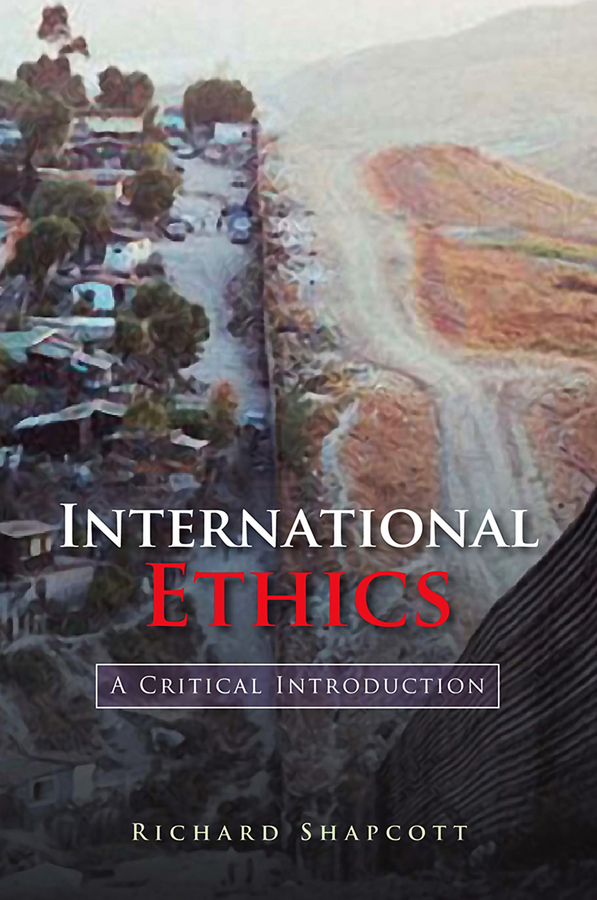
International Ethics Is it is justifiable to make any basic moral distinction between 'insiders and outsiders'? Do we have substantive duties of 'justice' to all human beings or merely Humanitarian duties of aid and assistance? These are two of the most crucial questions confronting world politics and the field of international ethics today. International Ethics: A Critical Introduction provides an engaging and accessible introduction to these foundational questions. In a cogent and carefully argued analysis, Richard Shapcott critically examines the theories of cosmopolitanism, communitarianism, realism and pluralism and scrutinises their approaches to the various obligations which members of 'bounded' communities, primarily nation-states, have to 'outsiders' and 'foreigners'. He then takes the theoretical approaches in context by discussing the ethics of hospitality and membership of political communities, issues of mutual aid and humanitarianism abroad, the ethics of harm related to interstate international violence, and the challenge of severe global poverty. The book concludes by suggesting that the terms of international ethical life in the 21st century require reframing in a way that focuses more intently on the nature of harm between communities and individuals. This book provides students and scholars with a conceptual framework with which to analyse the policies, actions and philosophy of governments, NGOs and international corporations. Above all, it offers the means whereby individuals can assess their own positions on contemporary ethical issues such as global poverty, humanitarian intervention, migration and refugees and global warming. POLITICAL SCIENCE,International Relations,General

Morgenthau The ideas of Hans Morgenthau dominated the study of international politics in the United States for many decades. He was the leading representative of Realist international relations theory in the last century and his work remains hugely influential in the field. In this engaging and accessible new study of his work, William E. Scheuerman provides a comprehensive and illuminating introduction to Morgenthau’s ideas, and assesses their significance for political theory and international politics. Scheuerman shows Morgenthau to be an uneasy Realist, uncomfortable with conventional notions of Realism and sometimes unsure whether his reflections should be grouped under its rubric. He was a powerful critic of the existing state system and defended the idea of a world state. By highlighting Morgenthau’s engagement with the leading lights of European political and legal theory, Scheuerman argues that he developed a morally demanding political ethics and an astute diagnosis of the unprecedented perils posed by nuclear weaponry. Believing that the irrationalities of US foreign policy were rooted partly in domestic factors, he sympathized with demands for radical political and social change. Scheuerman illustrates that Morgenthau’s thinking has been widely misunderstood by both disciples and critics and that it offers many challenges to contemporary Realists who discount his normative aspirations. With the advent of the cosmopolitan goal of international reform, Morgenthau’s work serves up an unsettling mix of sympathy and hard-headed skepticism which remains crucially important in the development of the field. Lucidly and persuasively written, this book will be a valuable resource for students and scholars seeking to understand the continued importance of Morgenthau’s thinking. POLITICAL SCIENCE,International Relations,General

Energy And International War Will international wars where energy resources play a central role continue to hold sway over life and death for industrialized nations, or is this a transient phase in the evolution of industrial societies? This book answers this question by tracing the history of energy and conflict from antiquity, through the epic hot and cold wars of the twentieth century, to expected outcome of the war in Iraq. It points the way to the end of wars over control of fossil fuels, and demonstrates why these may be the last major international wars over other resources as well.This book is a must-read for anyone interested in the future of energy use or international conflict. Readers will find in it an illuminating overview of the sweep of historical events. The book further provides a compelling explanation of how a thorough understanding of the evolutionary direction of these events challenges the conventional wisdom that resource wars are endemic to the nature of industrial society, thus offering a fresh view on one of the most important challenges of our time. POLITICAL SCIENCE,International Relations,General

Devil's Game The first complete account of America's most dangerous foreign policy miscalculation: sixty years of support for Islamic fundamentalism Devil's Game is the gripping story of America's misguided efforts, stretching across decades, to dominate the strategically vital Middle East by courting and cultivating Islamic fundamentalism. Among all the books about Islam, this is the first comprehensive inquiry into the touchiest issue: How and why did the United States encourage and finance the spread of radical political Islam? Backed by extensive archival research and interviews with dozens of policy makers and CIA, Pentagon, and foreign service officials, Robert Dreyfuss argues that this largely hidden relationship is greatly to blame for the global explosion of terrorism. He follows the trail of American collusion from support for the Muslim Brotherhood in 1950s Egypt to links with Khomeini and Afghani jihadists to cooperation with Hamas and Saudi Wahhabism. Dreyfuss also uncovers long-standing ties between radical Islamists and the leading banks of the West. The result is as tragic as it is paradoxical: originally deployed as pawns to foil nationalism and communism, extremist mullahs and ayatollahs now dominate the region, thundering against freedom of thought, science, women's rights, secularism—and their former patron. Wide-ranging and deeply informed, Devil's Game reveals a history of double-dealing, cynical exploitation, and humiliating embarrassment. What emerges is a pattern that, far from furthering democracy or security, ensures a future of blunders and blowback. POLITICAL SCIENCE,International Relations,General
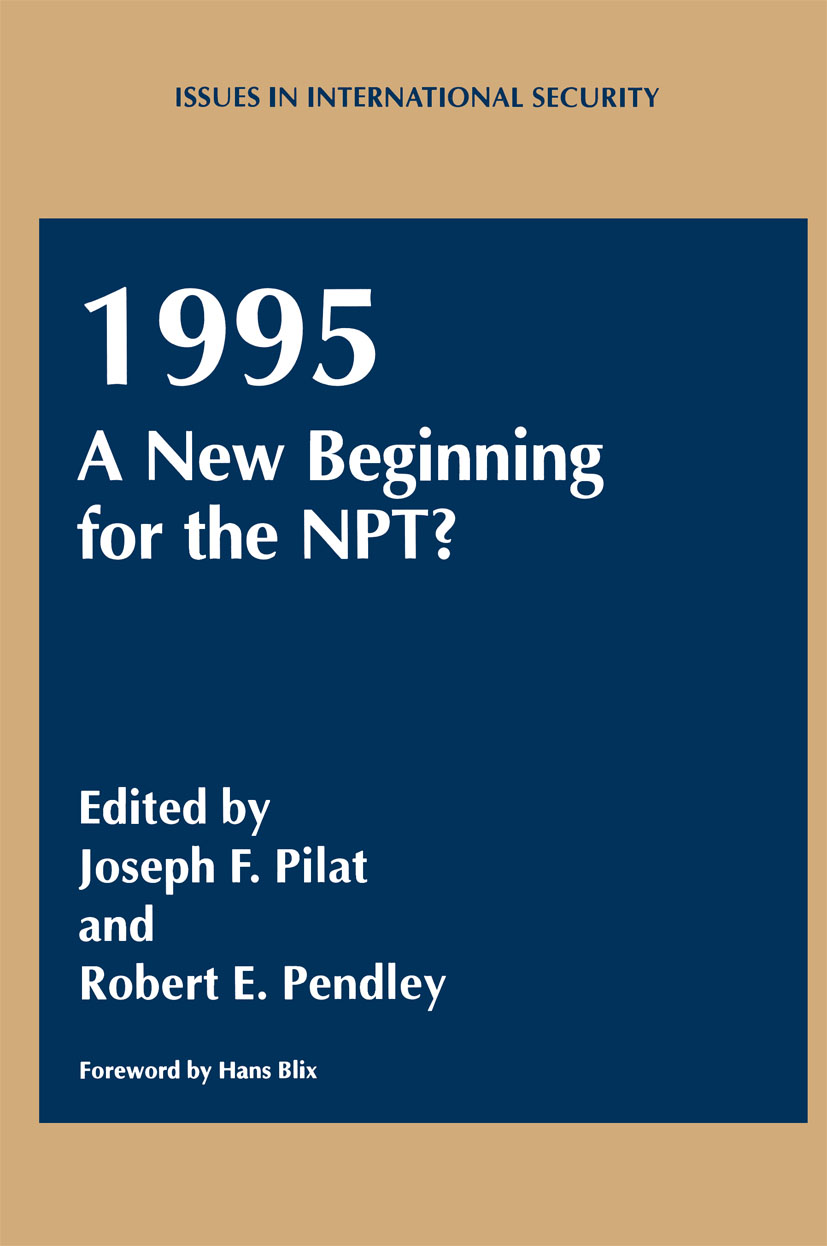
1995 As a follow-up to Beyond 1995: The Future of NPT published in 1990, this compilation presents the major issues to be addressed at the 1995 NPT Review and Extension Conference. Renowned academic and diplomatic authorities from around the world contribute original essays and address questions such as: - Will the NPT be faced with a fundamental challege to its existence? - Will the treaty be allowed to lapse? - Will states withdraw? - Will the NPT be succeeded by an alternative treaty or regime? POLITICAL SCIENCE,International Relations,General

Peace and Justice In recent years there has been a tendency to intervene in the military, political and economic affairs of failed and failing states and those emerging from violent conflict. In many cases this has been accompanied by some form of international judicial intervention to address serious and widespread abuses of international humanitarian law and human rights in recognition of an explicit link between peace and justice. A range of judicial and non-judicial approaches has been adopted in recognition of the fact that there is no one-size-fits-all model through which to seek accountability. This book considers the merits and drawbacks of these different responses and sets out an original framework for analysing transitional societies and transitional justice mechanisms. Taking as its starting point the post-Second World War tribunals at Nuremburg and Tokyo, the book goes on to discuss the creation of ad hoc international tribunals in the 1990s, hybrid/mixed courts, the International Criminal Court, domestic trials, truth commissions and traditional justice mechanisms. With examples drawn from across the world, including the former Yugoslavia, Rwanda, Cambodia, Timor-Leste, Sierra Leone, Uganda and the DRC, it presents a compelling and comprehensive study of the key responses to war crimes. Peace and Justice is a timely contribution in a world where an ever-increasing number of post-conflict societies are grappling with the complex issues of transitional justice. It will be a valuable resource for students, scholars, practitioners and policy-makers seeking to understand past violations of human rights and the most effective ways of addressing them. POLITICAL SCIENCE,International Relations,General
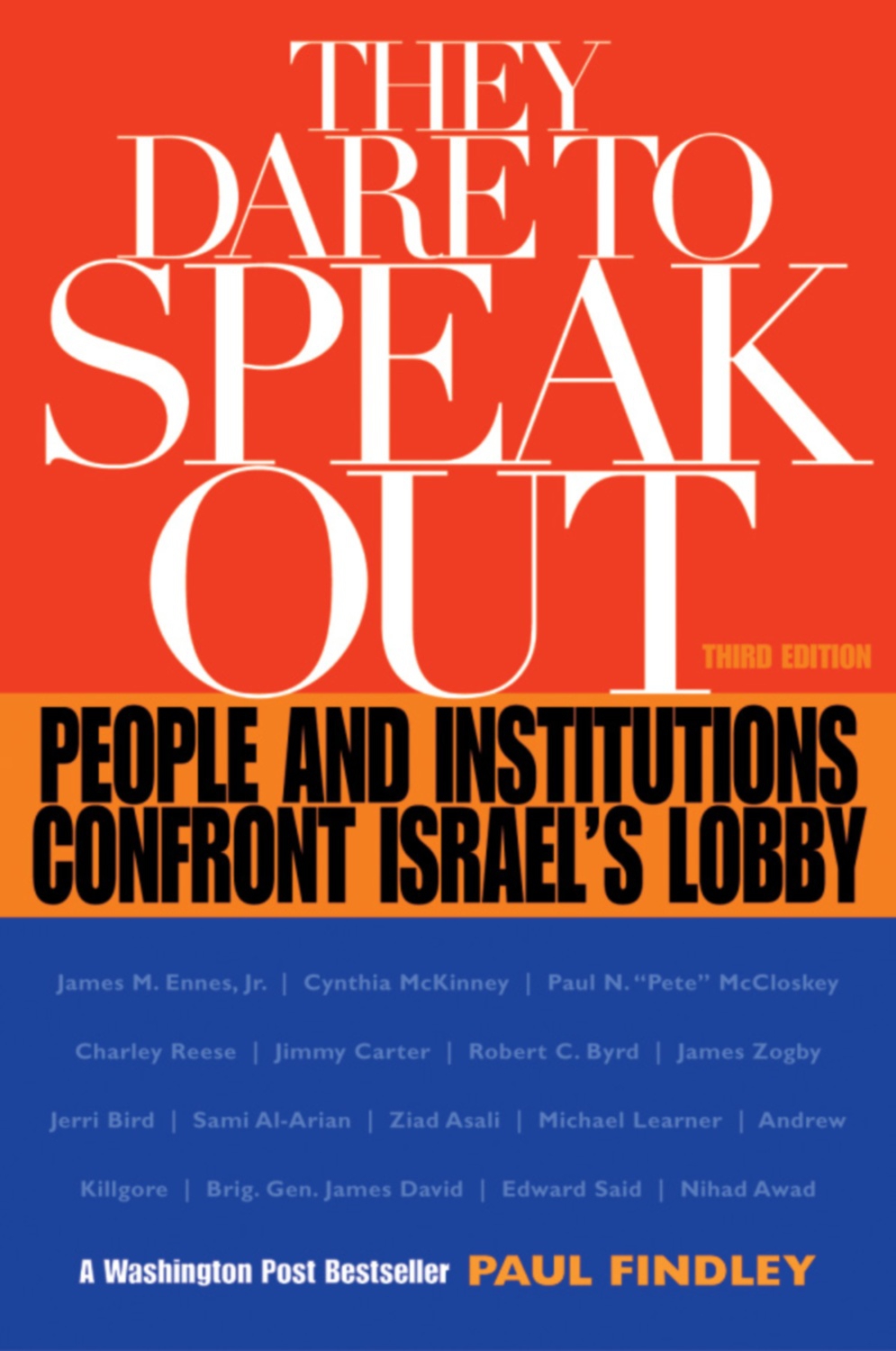
They Dare to Speak Out The first book to speak out against the pervasive influence of the American-Israeli Public Affairs Committee (AIPAC) on American politics, policy, and institutions resonates today as never before. With careful documentation and specific case histories, former congressman Paul Findley demonstrates how the Israel lobby helps to shape important aspects of U.S. foreign policy and influences congressional, senatorial, and even presidential elections. Described are the undue influence AIPAC exerts in the Senate and the House and the pressure AIPAC brings to bear on university professors and journalists who seem too sympathetic to Arab and Islamic states and too critical of Israel and its policies. Along with many longtime outspoken critics, new voices speaking out include former President Jimmy Carter, U.S. Representative Cynthia McKinney, Senator Robert Byrd, prominent Arab-American Dr. Ziad Asali, Rabbi Michael Lerner, and journalist Charles Reese. In addition, the lack of open debate among politicians with regard to the U.S. policy in the Middle East is lamented, and AIPAC is blamed in part for this censorship. Connections are drawn between America’s unconditional support of Israel and the raging anti-American passions around the worldand ultimately the tragic events of 9/11. This replaces 1556520735. POLITICAL SCIENCE,International Relations,General
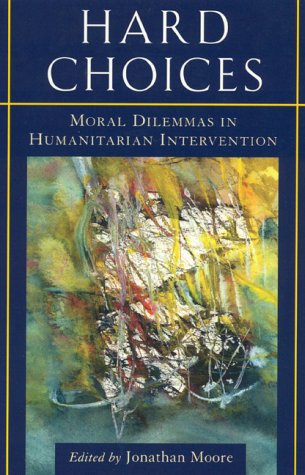
Hard Choices Since Somalia, the international community has found itself changing its view of humanitarian intervention. More attention must be paid to the complexity of issues and moral dilemmas involved. This volume of original essays by international policy leaders, practitioners, and scholars brings together insights into the conflicting moral pressures present in different kinds of interventions ranging from Rwanda and Somalia to Haiti, Cambodia, and Bosnia. Together the authors make the case that moral reflection and content can improve the quality of decisionmaking and intervention in internal conflicts, especially those that involve sanctions, refugees, human rights, development, and arms. Published under the auspices of The International Committee of the Red Cross. POLITICAL SCIENCE,International Relations,General

Intelligence in an Insecure World Over a decade on from the terrorist attacks of 9/11, intelligence continues to be of central importance to the contemporary world. Today there is a growing awareness of the importance of intelligence, and an increasing investment in it, as individuals, groups, organizations and states all seek timely and actionable information in order to increase their sense of security. But what exactly is intelligence? Who seeks to develop it and how? What happens to intelligence once it is produced, and what dilemmas does this generate? How can liberal democracies seek to mitigate problems of intelligence, and what do we mean by “intelligence failure?â€â€™ In a fully revised and expanded new edition of their classic guide to the field, Peter Gill and Mark Phythian explore these and other questions. Together they set out a comprehensive framework for the study of intelligence, discussing how ‘intelligence’ can best be understood, how it is collected, analysed, disseminated and acted upon, how it raises ethical problems, and how and why it fails. Drawing on a range of contemporary examples, Intelligence in an Insecure World is an authoritative and accessible guide to a rapidly expanding area of enquiry - one which everyone has an interest in understanding. POLITICAL SCIENCE,International Relations,General
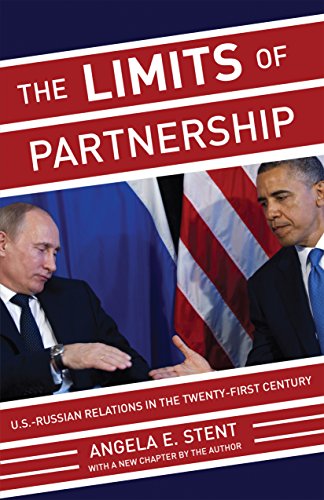
The Limits of Partnership A gripping account of U.S.-Russian relations since the end of the Soviet Union The Limits of Partnership is a riveting narrative about U.S.-Russian relations from the Soviet collapse through the Ukraine crisis and the difficult challenges ahead. It reflects the unique perspective of an insider who is also recognized as a leading expert on this troubled relationship. American presidents have repeatedly attempted to forge a strong and productive partnership only to be held hostage to the deep mistrust born of the Cold War. For the United States, Russia remains a priority because of its nuclear weapons arsenal, its strategic location bordering Europe and Asia, and its ability to support—or thwart—American interests. Why has it been so difficult to move the relationship forward? What are the prospects for doing so in the future? Is the effort doomed to fail again and again? What are the risks of a new Cold War? Angela Stent served as an adviser on Russia under Bill Clinton and George W. Bush, and maintains dialogues with key policymakers in both countries. Here, she argues that the same contentious issues—terrorism, missile defense, Iran, nuclear proliferation, Afghanistan, the former Soviet space, the greater Middle East—have been in every president's inbox, Democrat and Republican alike, since the collapse of the USSR. Stent vividly describes how Clinton and Bush sought inroads with Russia and staked much on their personal ties to Boris Yeltsin and Vladimir Putin—only to leave office with relations at a low point—and how Barack Obama managed to restore ties only to see them undermined by a Putin regime resentful of American dominance and determined to restore Russia's great power status. The Limits of Partnership calls for a fundamental reassessment of the principles and practices that drive U.S.-Russian relations, and offers a path forward to meet the urgent challenges facing both countries. This edition includes a new chapter in which Stent provides her insights about dramatic recent developments in U.S.-Russian relations, particularly the annexation of Crimea, war in Ukraine, and the end of the Obama Reset. POLITICAL SCIENCE,International Relations,General
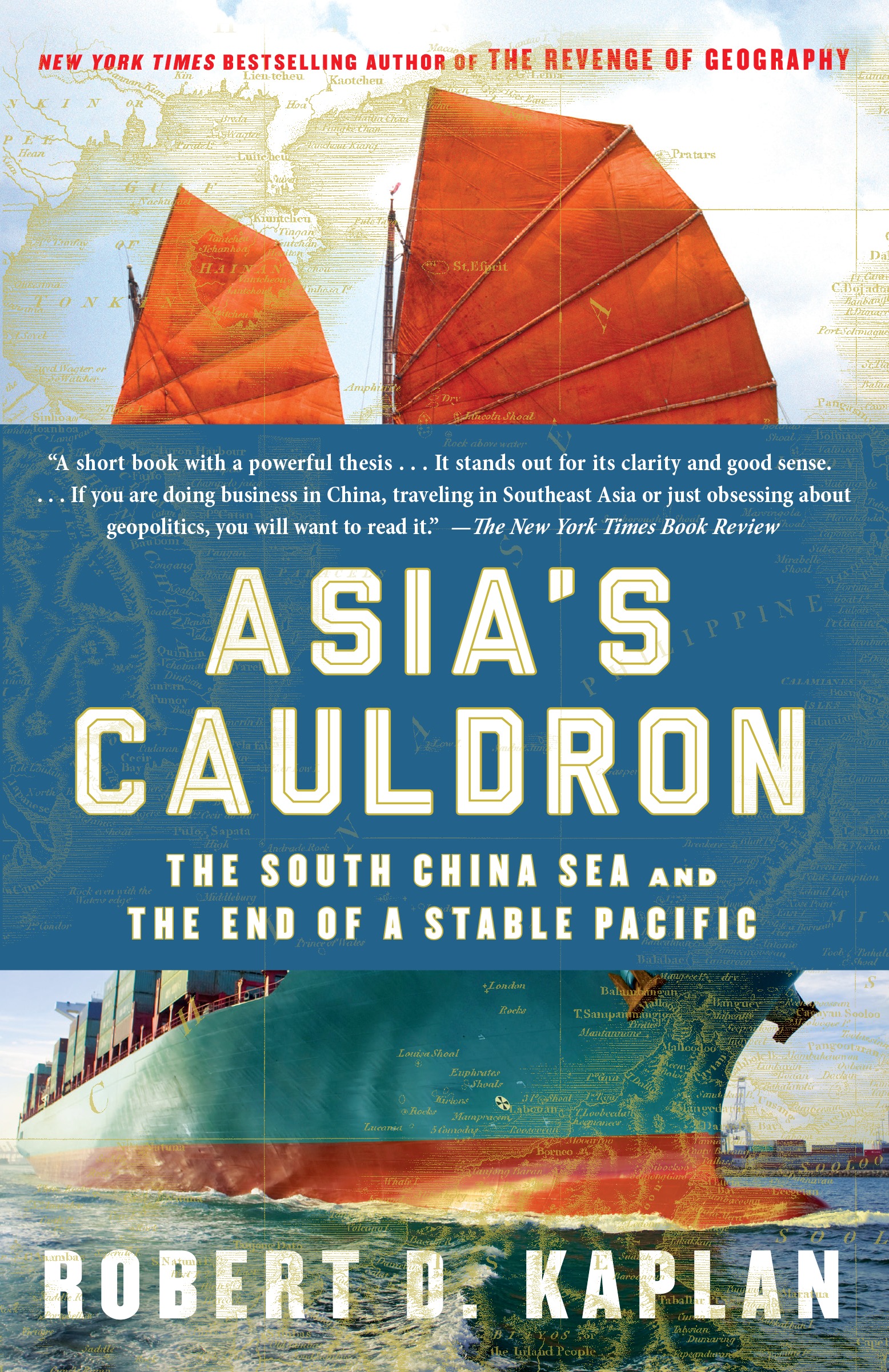
Asia's Cauldron NAMED ONE OF THE BEST BOOKS OF THE YEAR BY FINANCIAL TIMES From Robert D. Kaplan, named one of the world’s Top 100 Global Thinkers by Foreign Policy magazine, comes a penetrating look at the volatile region that will dominate the future of geopolitical conflict. Over the last decade, the center of world power has been quietly shifting from Europe to Asia. With oil reserves of several billion barrels, an estimated nine hundred trillion cubic feet of natural gas, and several centuries’ worth of competing territorial claims, the South China Sea in particular is a simmering pot of potential conflict. The underreported military buildup in the area where the Western Pacific meets the Indian Ocean means that it will likely be a hinge point for global war and peace for the foreseeable future. In Asia’s Cauldron, Robert D. Kaplan offers up a vivid snapshot of the nations surrounding the South China Sea, the conflicts brewing in the region at the dawn of the twenty-first century, and their implications for global peace and stability. One of the world’s most perceptive foreign policy experts, Kaplan interprets America’s interests in Asia in the context of an increasingly assertive China. He explains how the region’s unique geography fosters the growth of navies but also impedes aggression. And he draws a striking parallel between China’s quest for hegemony in the South China Sea and the United States’ imperial adventure in the Caribbean more than a century ago. To understand the future of conflict in East Asia, Kaplan argues, one must understand the goals and motivations of its leaders and its people. Part travelogue, part geopolitical primer, Asia’s Cauldron takes us on a journey through the region’s boom cities and ramshackle slums: from Vietnam, where the superfueled capitalism of the erstwhile colonial capital, Saigon, inspires the geostrategic pretensions of the official seat of government in Hanoi, to Malaysia, where a unique mix of authoritarian Islam and Western-style consumerism creates quite possibly the ultimate postmodern society; and from Singapore, whose “benevolent autocracy” helped foster an economic miracle, to the Philippines, where a different brand of authoritarianism under Ferdinand Marcos led not to economic growth but to decades of corruption and crime. At a time when every day’s news seems to contain some new story—large or small—that directly relates to conflicts over the South China Sea, Asia’s Cauldron is an indispensable guide to a corner of the globe that will affect all of our lives for years to come. Praise for Asia’s Cauldron “Asia’s Cauldron is a short book with a powerful thesis, and it stands out for its clarity and good sense. . . . If you are doing business in China, traveling in Southeast Asia or just obsessing about geopolitics, you will want to read it.”—The New York Times Book Review “Kaplan has established himself as one of our most consequential geopolitical thinkers. . . . [Asia’s Cauldron] is part treatise on geopolitics, part travel narrative. Indeed, he writes in the tradition of the great travel writers.”—The Weekly Standard “Kaplan’s fascinating book is a welcome challenge to the pessimists who see only trouble in China’s rise and the hawks who view it as malign.”—The Economist “Muscular, deeply knowledgeable . . . Kaplan is an ultra-realist [who] takes a non-moralistic stance on questions of power and diplomacy.”—Financial Times POLITICAL SCIENCE,International Relations,General
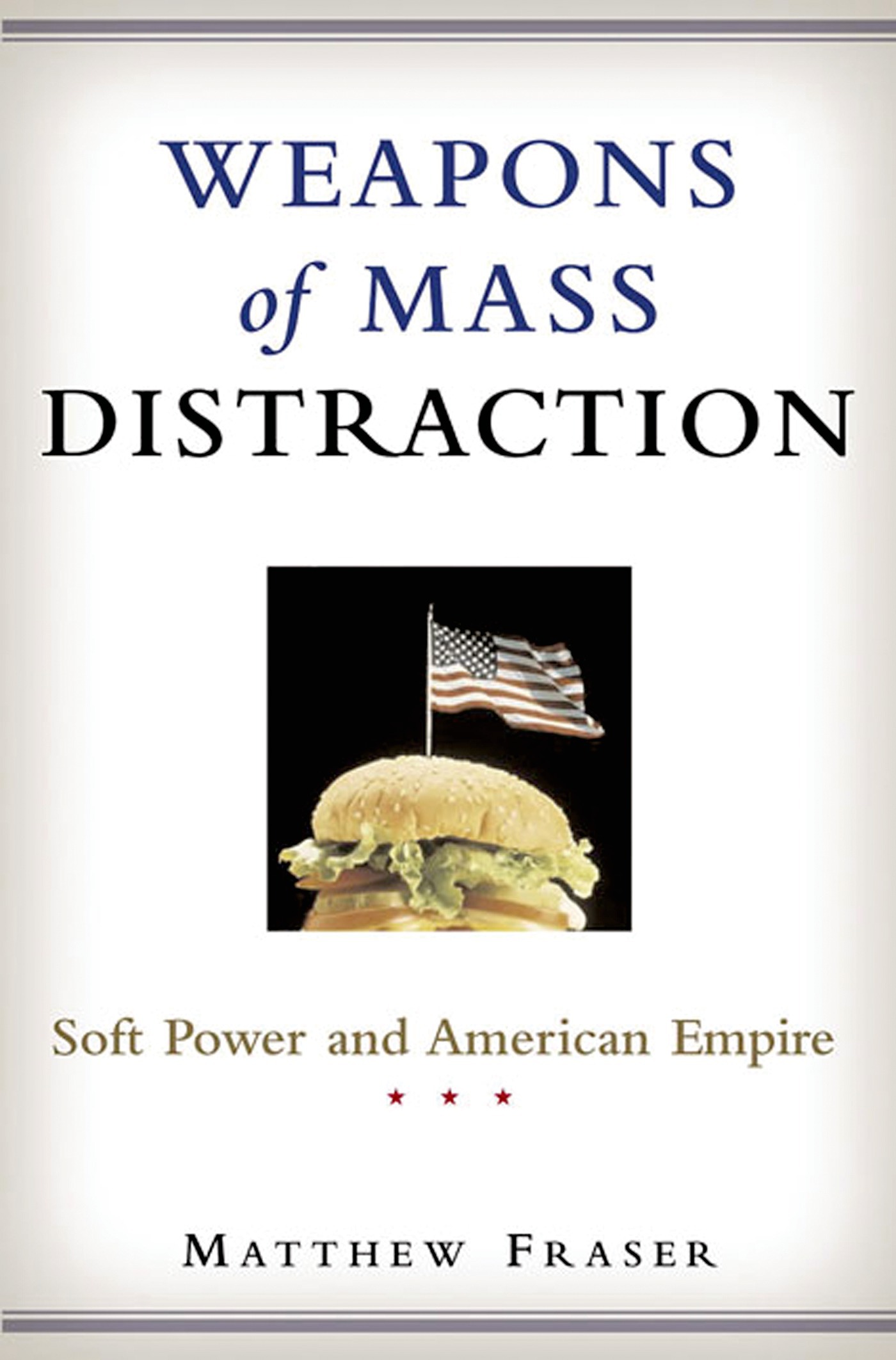
Weapons of Mass Distraction In its march to becoming the world's first hyper-power, the United States has been as dependent on its soft power - the allure of American lifestyles and culture - as it has been on the hard power of military might. In Weapons of Mass Distraction, Matthew Fraser examines the role of American pop cultural industries in international affairs. Fraser focuses on the major areas of soft power - movies, television, pop music, and fast food - and traces the origins, history and current influence of these on U.S. foreign policy. He describes how the American film, television, and music industries enjoy a ubiquitous global presence that has made them indispensable to the U.S. government, which has often gone so far as to fund them directly, including the White House-sponsored radio station in the Middle East launched with the hopes of winning over Muslim youths with American pop songs. A Coca-Cola lobbyist once famously declared that "The best barometer of the relationship of the U.S. and any other country is the way Coca-Cola is treated." Fraser proves this claim isn't to be taken lightly. He charts the global spread of the fast food industry, the role of Coca-Cola and McDonald's in American foreign policy and the recent rise of their opponents: the anti-globalization movement. Do things really go better with Coca-Cola? Fraser's answer is a resounding yes. While American soft power remains a contentious issue, he believes it promotes values and beliefs that are ultimately good for the rest of the world. Still, what are the future implications of American soft power? Will national identities decline as the world order is transformed into a state of "electronic feudalism" where there is no central power? Weapons of Mass Distraction provides an engaging, enlightening, and provocative look at the future of American foreign policy and popular culture in the 21st century. POLITICAL SCIENCE,International Relations,General

Israeli-Romanian Relations at the End of the Ceausescu Era Yosef Govrin was the Israeli Ambassador to Romania in the twilight of the communist era. Govrin describes Israeli-Romanian relations as he observed them from 1985 to 1989 after which the leader of Romania was deposed. POLITICAL SCIENCE,International Relations,General
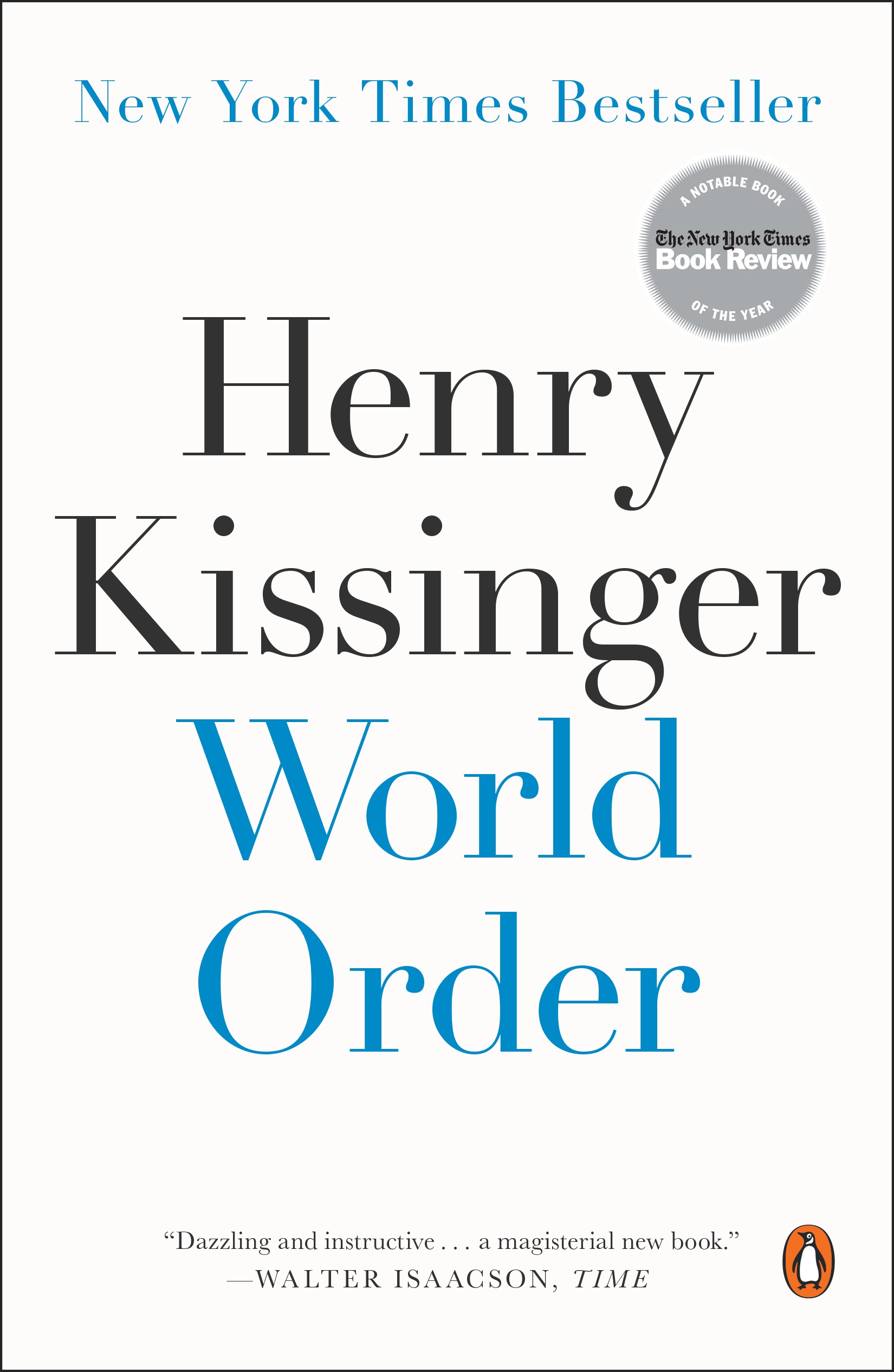
World Order “Dazzling and instructive . . . [a] magisterial new book.” —Walter Isaacson, Time Henry Kissinger offers in World Order a deep meditation on the roots of international harmony and global disorder. Drawing on his experience as one of the foremost statesmen of the modern era—advising presidents, traveling the world, observing and shaping the central foreign policy events of recent decades—Kissinger now reveals his analysis of the ultimate challenge for the twenty-first century: how to build a shared international order in a world of divergent historical perspectives, violent conflict, proliferating technology, and ideological extremism. There has never been a true “world order,” Kissinger observes. For most of history, civilizations defined their own concepts of order. Each considered itself the center of the world and envisioned its distinct principles as universally relevant. China conceived of a global cultural hierarchy with the emperor at its pinnacle. In Europe, Rome imagined itself surrounded by barbarians; when Rome fragmented, European peoples refined a concept of an equilibrium of sovereign states and sought to export it across the world. Islam, in its early centuries, considered itself the world’s sole legitimate political unit, destined to expand indefinitely until the world was brought into harmony by religious principles. The United States was born of a conviction about the universal applicability of democracy—a conviction that has guided its policies ever since. Now international affairs take place on a global basis, and these historical concepts of world order are meeting. Every region participates in questions of high policy in every other, often instantaneously. Yet there is no consensus among the major actors about the rules and limits guiding this process or its ultimate destination. The result is mounting tension. Grounded in Kissinger’s deep study of history and his experience as national security advisor and secretary of state, World Order guides readers through crucial episodes in recent world history. Kissinger offers a unique glimpse into the inner deliberations of the Nixon administration’s negotiations with Hanoi over the end of the Vietnam War, as well as Ronald Reagan’s tense debates with Soviet Premier Gorbachev in Reykjavík. He offers compelling insights into the future of U.S.–China relations and the evolution of the European Union, and he examines lessons of the conflicts in Iraq and Afghanistan. Taking readers from his analysis of nuclear negotiations with Iran through the West’s response to the Arab Spring and tensions with Russia over Ukraine, World Order anchors Kissinger’s historical analysis in the decisive events of our time. Provocative and articulate, blending historical insight with geopolitical prognostication, World Order is a unique work that could come only from a lifelong policy maker and diplomat. Kissinger is also the author of On China. POLITICAL SCIENCE,International Relations,General
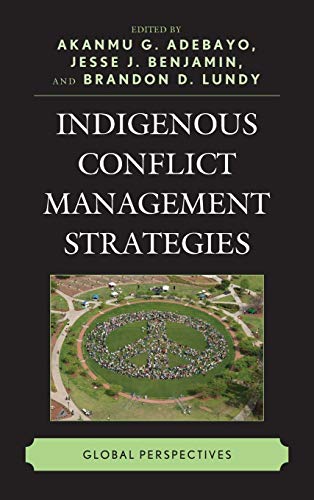
Indigenous Conflict Management Strategies This book presents a variety of traditional conflict management approaches as well as several cases of successful and unsuccessful integrations of indigenous and Western strategies. As it explores these methods, the book also analyzes the central characteristics, strengths, and weaknesses of a multitude of indigenous systems from around the globe. POLITICAL SCIENCE,International Relations,General
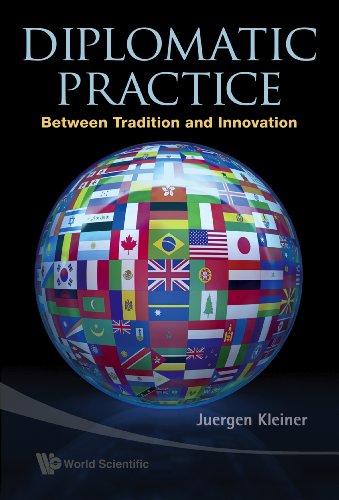
Diplomatic Practice This book presents a comprehensive overview of the current international practice of diplomacy. Armed with over 30 years of experience in the German Foreign Service, the author explains the workings of the different actors on the diplomatic stage. The book provides a detailed coverage of various diplomatic agencies as well as the functions of diplomats and consuls, explaining the methods and protocols of the art of diplomacy. It will serve as a good reference source for students and scholars of diplomacy, diplomats in foreign ministries and diplomatic and consular missions. POLITICAL SCIENCE,International Relations,General
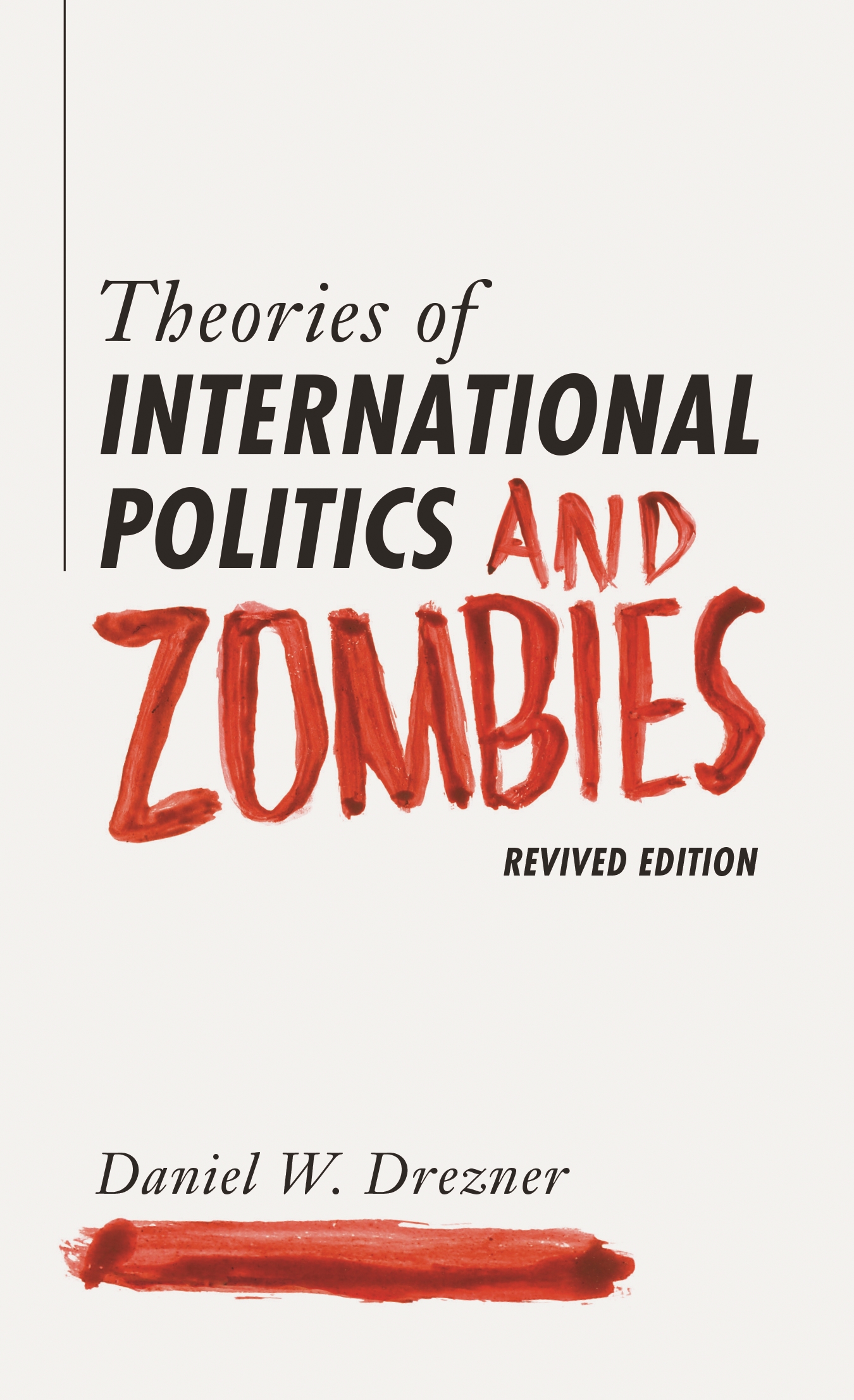
Theories of International Politics and Zombies What would happen to international politics if the dead rose from the grave and started to eat the living? Daniel Drezner's groundbreaking book answers the question that other international relations scholars have been too scared to ask. Addressing timely issues with analytical bite, Drezner looks at how well-known theories from international relations might be applied to a war with zombies. Exploring the plots of popular zombie films, songs, and books, Theories of International Politics and Zombies predicts realistic scenarios for the political stage in the face of a zombie threat and considers how valid—or how rotten—such scenarios might be. This newly revived edition includes substantial updates throughout as well as a new epilogue assessing the role of the zombie analogy in the public sphere. POLITICAL SCIENCE,International Relations,General

An Introduction to the English School of International Relations This outstanding book is the first comprehensive introduction to the English School of International Relations. Written by leading ES scholar Barry Buzan, it expertly guides readers through the English School’s formative ideas, intellectual and historical roots, current controversies and future avenues of development. Part One sets out the English School’s origins and development, explaining its central concepts and methodological tools, and placing it within the broader canon of IR theory. Part Two offers a detailed account of the historical, regional and social structural strands of the English School, explaining the important link between the school’s historical projects and its interest in a societal approach to international relations. Part Three explores the School’s responses to the enduring problems of order and justice, and highlights the changing balance between pluralist and solidarist institutions in the evolution of international society over the past five centuries. The book concludes with a discussion of the English School’s ongoing controversies and debates, and identifies opportunities for further research. For students new to the topic this book will provide an accessible and balanced overview, whilst those already familiar with the ES will be prompted to look afresh at their own understanding of its significance and potentiality. POLITICAL SCIENCE,International Relations,General

After Fidel A chief U.S. intelligence officer tells the inside story of Fidel Castro's 40-year rule and the man who will in all probability succeed him--his brother Raul POLITICAL SCIENCE,International Relations,General

Base Nation From Italy to the Indian Ocean, from Japan to Honduras, a far-reaching examination of the perils of American military bases overseas American military bases encircle the globe. More than two decades after the end of the Cold War, the U.S. still stations its troops at nearly a thousand locations in foreign lands. These bases are usually taken for granted or overlooked entirely, a little-noticed part of the Pentagon's vast operations. But in an eye-opening account, Base Nation shows that the worldwide network of bases brings with it a panoply of ills—and actually makes the nation less safe in the long run. As David Vine demonstrates, the overseas bases raise geopolitical tensions and provoke widespread antipathy towards the United States. They also undermine American democratic ideals, pushing the U.S. into partnerships with dictators and perpetuating a system of second-class citizenship in territories like Guam. They breed sexual violence, destroy the environment, and damage local economies. And their financial cost is staggering: though the Pentagon underplays the numbers, Vine's accounting proves that the bill approaches $100 billion per year.For many decades, the need for overseas bases has been a quasi-religious dictum of U.S. foreign policy. But in recent years, a bipartisan coalition has finally started to question this conventional wisdom. With the U.S. withdrawing from Afghanistan and ending thirteen years of war, there is no better time to re-examine the tenets of our military strategy. Base Nation is an essential contribution to that debate. POLITICAL SCIENCE,International Relations,General
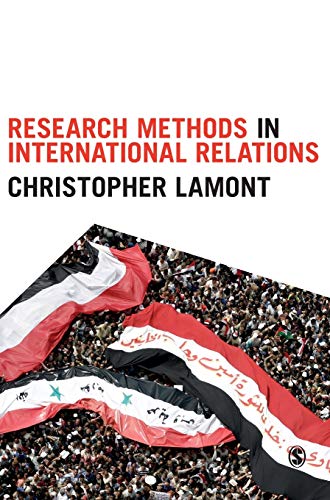
Research Methods in International Relations Focussing specifically on methods most relevant to International Relations, this exciting new text guides students through the entire research process and provides students with plenty of specific examples, table and figures and suggested further readings POLITICAL SCIENCE,International Relations,General
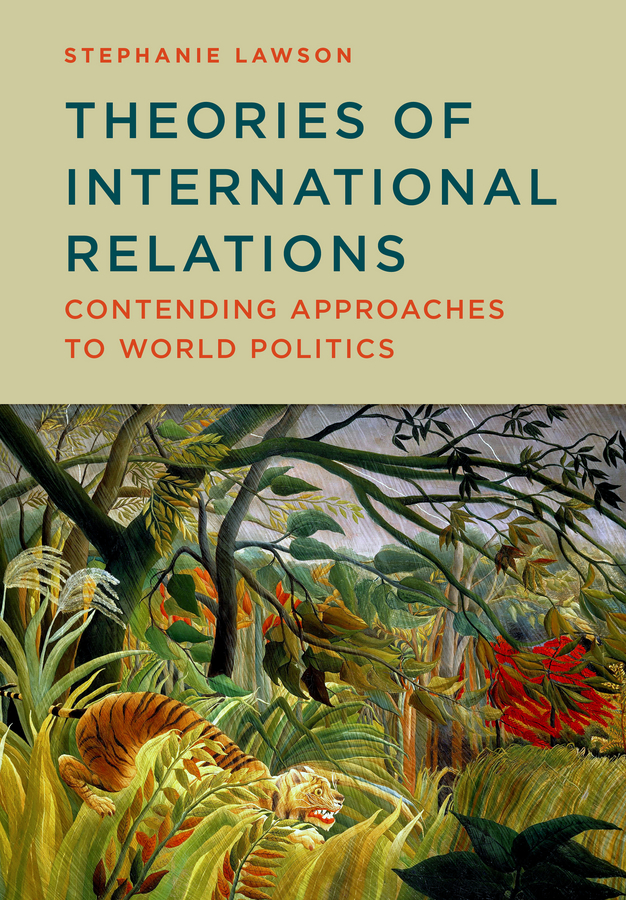
Theories of International Relations Since the field of International Relations was established almost a century ago, many different theoretical approaches have been developed, each offering distinctive accounts of the world, why it has come to be the way it is, and how it might be made a better place. In this illuminating textbook, leading IR scholar, Stephanie Lawson, examines each of these theories in turn, from political realism in its various forms to liberalism, Marxism, critical theory and more recent contributions from social theory, feminism, postcolonialism and green theory. Taking as her focus the major practical issues facing scholars of international relations today, Lawson ably shows how each theory relates to situations ?on the ground?. Each chapter features case studies, questions for discussion to encourage reflection and classroom debate, guides to further reading and web resources. The study of IR is a profoundly normative enterprise, and each theoretical school has its strengths and weaknesses. Theories of International Relations encourages a critical, reflective approach to the study of IR theory, while emphasising the many important and interesting things it has to teach us about the complexities and challenges of international politics today. POLITICAL SCIENCE,International Relations,General
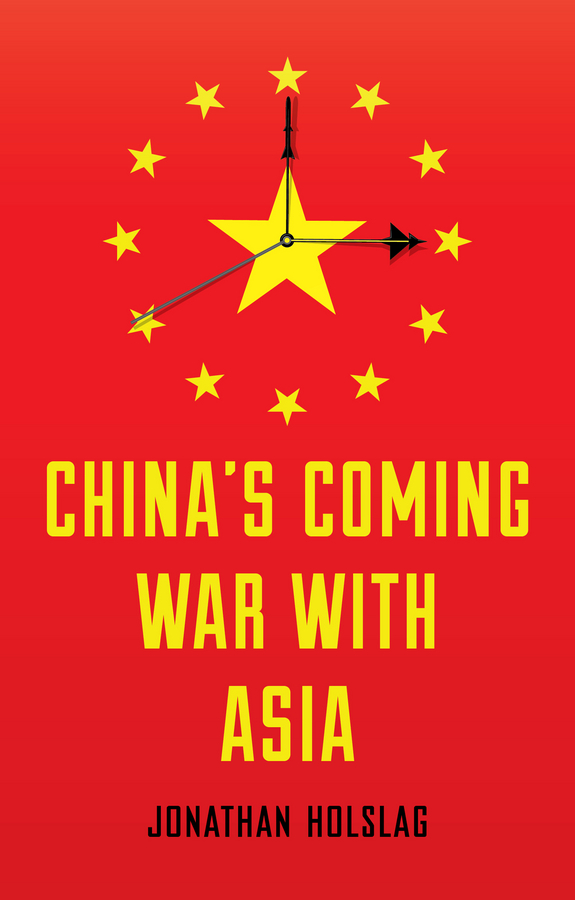
China's Coming War with Asia China?s ambition is to rise peacefully. Avoiding fierce conflicts with its Asian neighbors is essential to this goal. Jonathan Holslag makes a brilliant case for the geopolitical dilemma facing the rising China, and his argument that China will likely enter into major conflict with Asia is compelling and thoughtful. Both Chinese experts and decision-makers will find this book illuminating reading. Asia is set for another great power war. As China?s influence spreads beyond its territorial borders and its global aspirations gain momentum, so tensions with its neighbors are reaching breaking point. In this clear-sighted book, Jonathan Holslag debunks the myth of China?s peaceful rise, arguing instead that China?s policy of shrewd intransigence towards other Asian countries will inevitably result in serious conflict. China?s ambitions are not malicious. But what China wants ? namely to maximize its security and prosperity ? will lead to a huge power imbalance, where China towers above her neighbors, impels them into unequal partnerships, and is increasingly able to seize disputed territory. At present, China?s focused and uncompromising pursuit of its own interests is bearing fruit. Many of China?s neighbors are still too weak to counter Beijing?s influence, and China has ably exploited divisions between them to divide and rule. But several regional powers are now joining forces to stop China. With the PRC unlikely to back down and nationalism riding high, China?s coming war with Asia is already in the making. POLITICAL SCIENCE,International Relations,General

What is Genocide? This fully revised edition of Martin Shaw’s classic, award-winning text proposes a way through the intellectual confusion surrounding genocide. In a thorough account of the idea’s history, Shaw considers its origins and development and its relationships to concepts like ethnic cleansing and politicide. Offering a radical critique of the existing literature on genocide, he argues that what distinguishes genocide from more legitimate warfare is that the ‘enemies’ targeted are groups and individuals of a civilian character. He vividly illustrates his argument with a wide range of historical examples - from the Holocaust to Rwanda and Palestine to Yugoslavia - and shows how the question ‘What is genocide?’ matters politically whenever populations are threatened by violence. The second edition of this compelling book will continue to spark interest and vigorous debate, appealing to students and scholars across the social sciences and in international law. POLITICAL SCIENCE,International Relations,General

Great Powers and Geopolitics This book presents the theoretical-historical-comparative political framework needed to fully grasp the truly dynamic nature of 21st century global affairs. The author provides a realistic assessment of the shift from U.S predominance to a new mix of counterbalancing rival middle-tier and assertive regional powers, while highlighting those geopolitical zones of contention most critical for future international stability. The book will appeal to scholars and policy makers interested in understanding the contours of the emerging world order, and in identifying its principal shapers and leading political actors. POLITICAL SCIENCE,International Relations,General

Boycotting Israel Is Wrong The BDS movement (boycott, divestment, sanctions) against Israel has gained traction and publicity worldwide for a decade. Yet here, Philip Mendes and Nick Dyrenfurth – two politically progressive commentators – argue that BDS is far too blunt an instrument to use in a such a complex political situation. Instead, they critically analyze the key arguments for and against BDS, and propose a solution that supports Israel's existence and Palestinian rights to a homeland, urging mutual compromise and concessions from both sides. POLITICAL SCIENCE,International Relations,General

Readings in American Foreign Policy Comprised of the most recent journal articles, government documents, and think tank pieces, Readings in American Foreign Policy looks at contemporary problems and responses to U.S. foreign policy around the world. POLITICAL SCIENCE,International Relations,General

Preventive Force Examines the recent rise in the United States' use of preventive force More so than in the past, the US is now embracing the logic of preventive force: using military force to counter potential threats around the globe before they have fully materialized. While popular with individuals who seek to avoid too many “boots on the ground,†preventive force is controversial because of its potential for unnecessary collateral damage. Who decides what threats are ‘imminent’? Is there an international legal basis to kill or harm individuals who have a connection to that threat? Do the benefits of preventive force justify the costs? And, perhaps most importantly, is the US setting a dangerous international precedent? In Preventive Force, editors Kerstin Fisk and Jennifer Ramos bring together legal scholars, political scientists, international relations scholars, and prominent defense specialists to examine these questions, whether in the context of full-scale preventive war or preventive drone strikes. In particular, the volume highlights preventive drones strikes, as they mark a complete transformation of how the US understands international norms regarding the use of force, and could potentially lead to a ‘slippery slope’ for the US and other nations in terms of engaging in preventive warfare as a matter of course. A comprehensive resource that speaks to the contours of preventive force as a security strategy as well as to the practical, legal, and ethical considerations of its implementation, Preventive Force is a useful guide for political scientists, international relations scholars, and policymakers who seek a thorough and current overview of this essential topic. POLITICAL SCIENCE,International Relations,General

Monetary Stability through International Cooperation Monetary Stability through International Cooperation contains essays written by high ranking policy makers in the field of central banking and international finance, written in honour of André Szász, who has been Executive Director of De Nederlandsche Bank since 1973, responsible for international monetary relations. Colleagues from several other central banks, from finance ministries and from international institutions pay tribute to him by analysing the conditions fostering European as well as global monetary stability. The book provides an inside view of the thinking of monetary officials at the turn of 1993/1994, when the currency turmoil in the ERM of mid-1993 had subsided and views on its implications for exchange rate management and, more generally, for European integration were taking shape. Topics include exchange rate stabilisation, policy coordination and central bank independence. A second section, on the international monetary system, includes essays on the policy implications of present day dynamic financial markets as well as the role of the IMF. This book, written by `insiders for an insider', provides valuable insights to those who are interested in contemporary international monetary relations. POLITICAL SCIENCE,International Relations,General
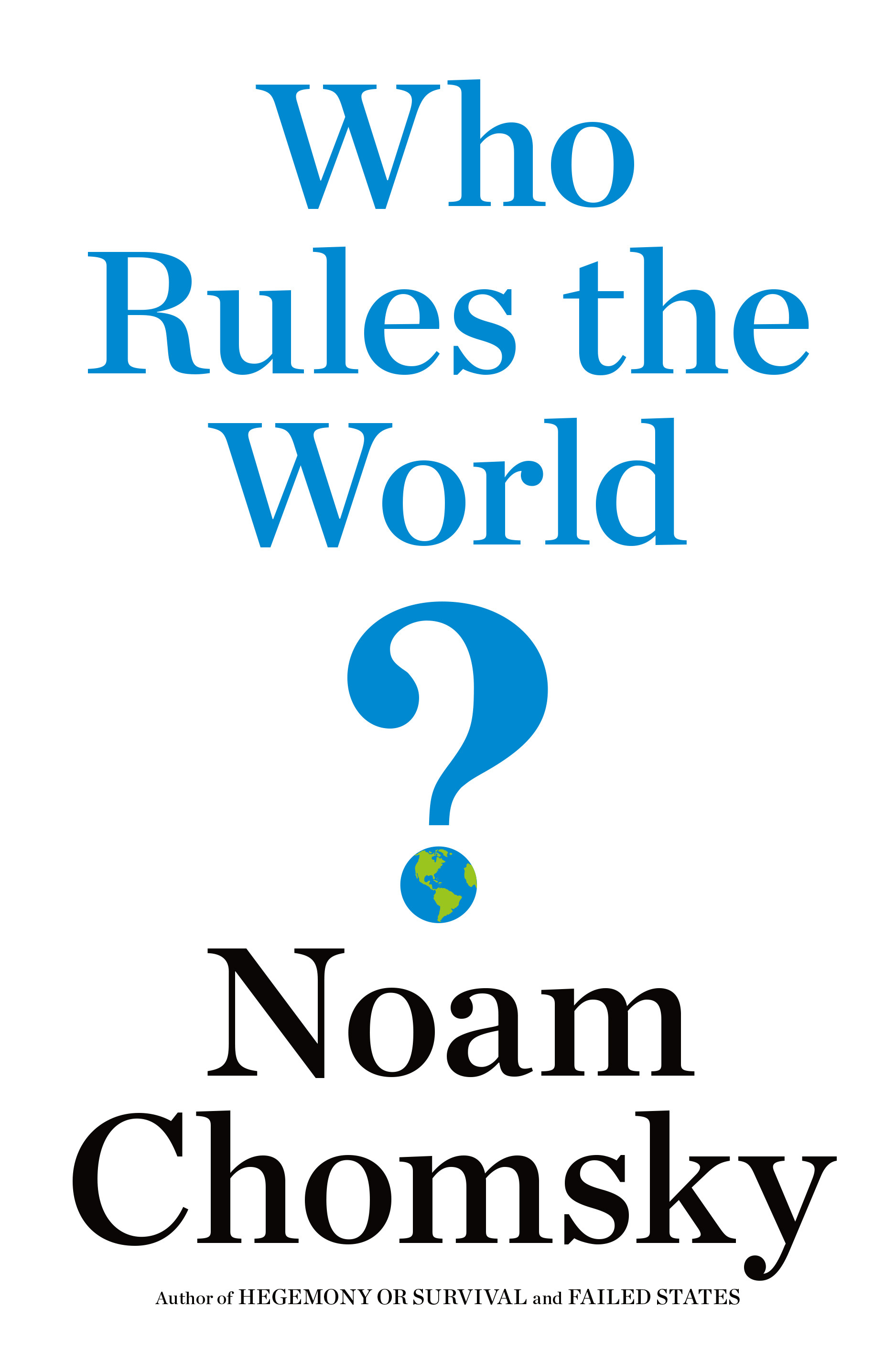
Who Rules the World? A New York Times Bestseller The world’s leading intellectual offers a probing examination of the waning American Century, the nature of U.S. policies post-9/11, and the perils of valuing power above democracy and human rights In an incisive, thorough analysis of the current international situation, Noam Chomsky argues that the United States, through its military-first policies and its unstinting devotion to maintaining a world-spanning empire, is both risking catastrophe and wrecking the global commons. Drawing on a wide range of examples, from the expanding drone assassination program to the threat of nuclear warfare, as well as the flashpoints of Iraq, Iran, Afghanistan, and Israel/Palestine, he offers unexpected and nuanced insights into the workings of imperial power on our increasingly chaotic planet. In the process, Chomsky provides a brilliant anatomy of just how U.S. elites have grown ever more insulated from any democratic constraints on their power. While the broader population is lulled into apathy—diverted to consumerism or hatred of the vulnerable—the corporations and the rich have increasingly been allowed to do as they please. Fierce, unsparing, and meticulously documented, Who Rules the World? delivers the indispensable understanding of the central conflicts and dangers of our time that we have come to expect from Chomsky. POLITICAL SCIENCE,International Relations,General

How Everything Became War and the Military Became Everything “A dynamic work of reportage†(The New York Times) written “with clarity and...wit†(The New York Times Book Review) about what happens when the ancient boundary between war and peace is erased. Once, war was a temporary state of affairs. Today, America’s wars are everywhere and forever: our enemies change constantly and rarely wear uniforms, and virtually anything can become a weapon. As war expands, so does the role of the US military. Military personnel now analyze computer code, train Afghan judges, build Ebola isolation wards, eavesdrop on electronic communications, develop soap operas, and patrol for pirates. You name it, the military does it. In this “ambitious and astute†(The Washington Post) work, Rosa Brooks “provides a masterful analysis†(San Francisco Chronicle) of this seismic shift in how America wages war from an unconventional perspective—that of a former top Pentagon official who is the daughter of two anti-war protesters and married to an Army Green Beret. By turns a memoir, a work of journalism, a scholarly exploration of history, anthropology, and law, How Everything Became War and the Military Became Everything is an “illuminating†(The New York Times), “eloquent†(The Boston Globe), “courageous†(US News & World Report), and “essential†(The Dallas Morning News) examination of the role of the military today. Above all, it is a rallying cry, for Brooks issues an urgent warning: When the boundaries around war disappear, we undermine both America’s founding values and the international rules and organizations that keep our world from sliding towards chaos. POLITICAL SCIENCE,International Relations,General
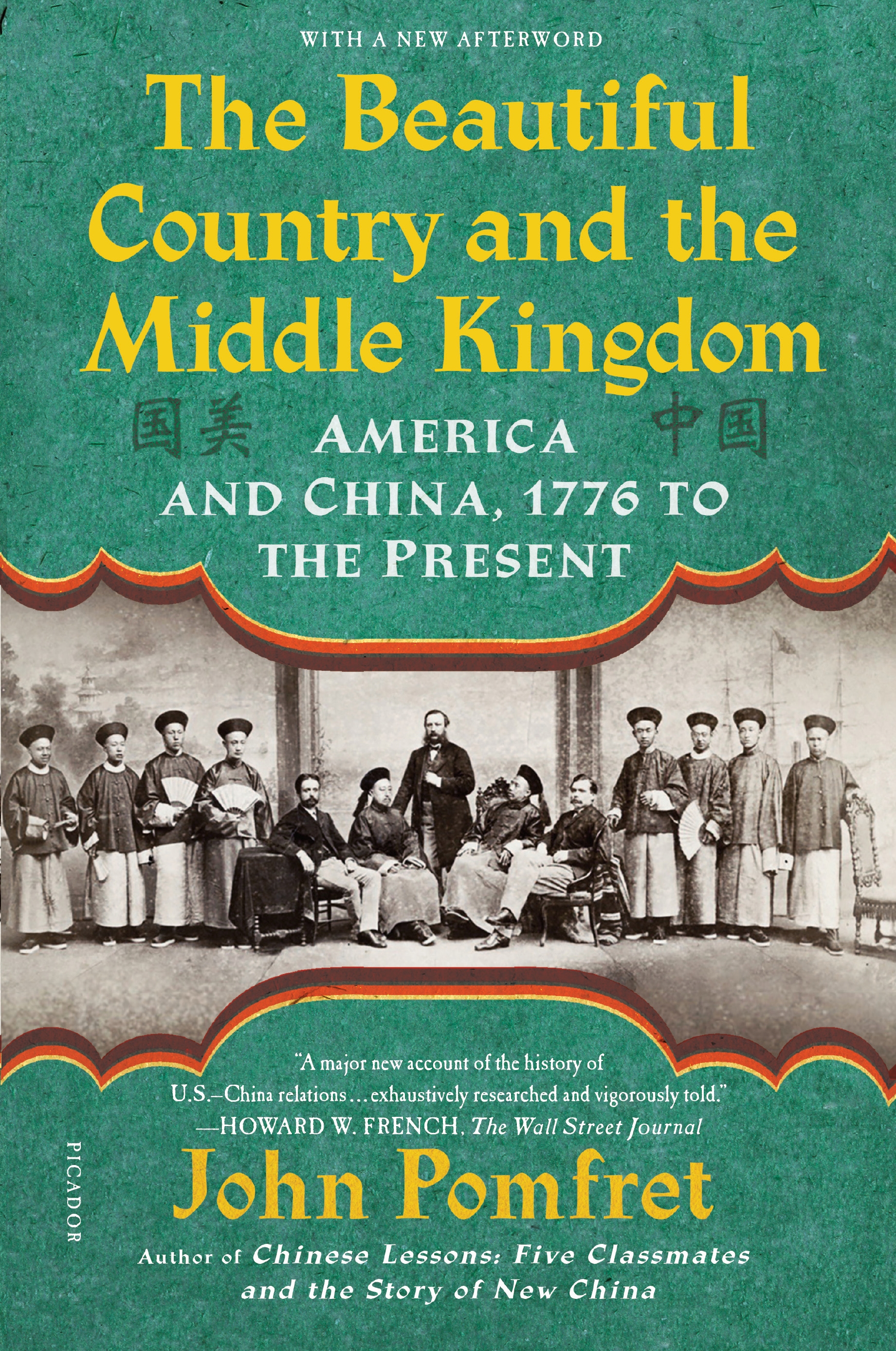
The Beautiful Country and the Middle Kingdom A remarkable history of the two-centuries-old relationship between the United States and China, from the Revolutionary War to the present day From the clipper ships that ventured to Canton hauling cargos of American ginseng to swap Chinese tea, to the US warships facing off against China's growing navy in the South China Sea, from the Yankee missionaries who brought Christianity and education to China, to the Chinese who built the American West, the United States and China have always been dramatically intertwined. For more than two centuries, American and Chinese statesmen, merchants, missionaries, and adventurers, men and women, have profoundly influenced the fate of these nations. While we tend to think of America's ties with China as starting in 1972 with the visit of President Richard Nixon to China, the patterns—rapturous enchantment followed by angry disillusionment—were set in motion hundreds of years earlier. Drawing on personal letters, diaries, memoirs, government documents, and contemporary news reports, John Pomfret reconstructs the surprising, tragic, and marvelous ways Americans and Chinese have engaged with one another through the centuries. A fascinating and thrilling account, The Beautiful Country and the Middle Kingdom is also an indispensable book for understanding the most important—and often the most perplexing—relationship between any two countries in the world. POLITICAL SCIENCE,International Relations,General

East Asian Regionalism East Asia is one of the world's most dynamic and diverse regions and is also becoming an increasingly coherent region through the inter-play of various integrative economic, political and socio-cultural processes. Fully updated and revised throughout, this new edition explores the various ways in which East Asian regionalism continues to deepen. The second edition has been expanded to incorporate coverage of significant issues that have emerged in recent years including: Growing tensions in the region over maritime territory and historical issues Competing regional free trade agreement negotiations The impact of the global financial crisis on financial co-operation and engagement with global governance Obama’s ‘pivot to Asia’ and developments in US relations with East Asia The influence of new technology and social media on micro-level regional relations The growing importance of ‘new diplomacy’ issues such as energy security, climate change, food security and international migration. Key pedagogical features include: end of chapter 'study questions' case studies that discuss topical issues with study questions also provided useful tables and figures which illustrate key regional trends in East Asia Extensive summary conclusions covering the chapter's main findings from different international political economy perspectives. East Asian Regionalism is an essential text for courses on East Asian regionalism, Asian politics and Asian economics. POLITICAL SCIENCE,International Relations,General

The UK’s Relationship with Europe This book provides an accessible and timely analysis of how the British discourse on Europe has evolved over the past forty years. It focuses on three key episodes: the 1975 referendum on the UK’s continued membership of the European Economic Community; the 1992-3 debates on ratification of the Maastricht Treaty; and the more recent proto-referendum debates sparked by David Cameron’s Bloomberg speech in January 2013. Using a discourse-analytical approach, the book analyses how political and media voices seek to delineate a British sense of self from a Continental other. Importantly, the book also pays close attention to the rising prominence of immigration issues within the British discourse on Europe. POLITICAL SCIENCE,International Relations,General

Cases in Intelligence Analysis In their Second Edition of Cases in Intelligence Analysis: Structured Analytic Techniques in Action , accomplished instructors and intelligence practitioners Sarah Miller Beebe and Randolph H. Pherson offer robust, class-tested cases studies of events in foreign intelligence, counterintelligence, terrorism, homeland security, law enforcement, and decision-making support. Designed to give analysts-in-training an opportunity to apply structured analytic techniques and tackle real-life problems, each turnkey case delivers a captivating narrative, discussion questions, recommended readings, and a series of engaging analytic exercises. POLITICAL SCIENCE,International Relations,General
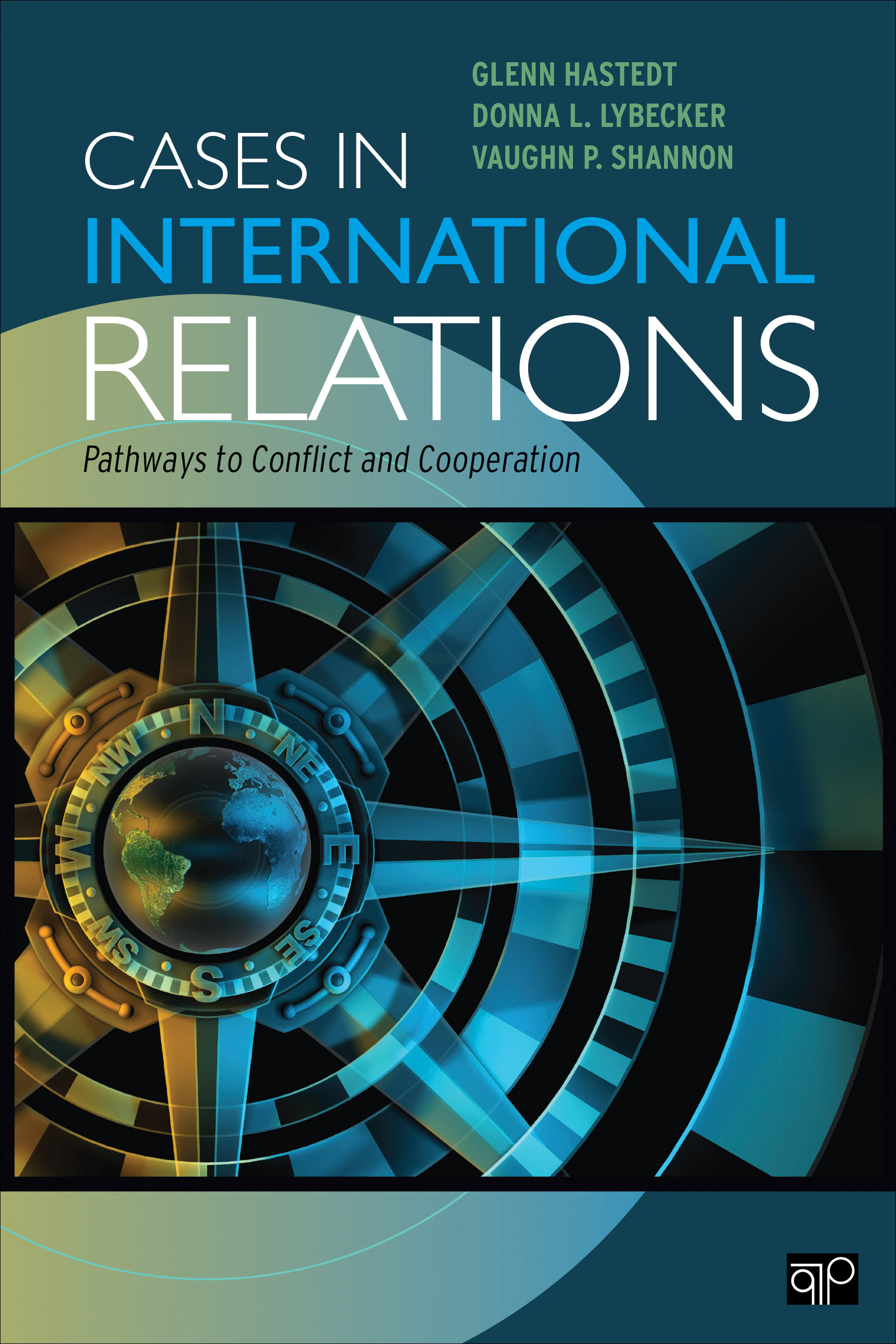
Cases in International Relations Students love good stories. That is why case studies are such a powerful way to engage students while teaching them about concepts fundamental to the study of international relations. In Cases in International Relations, Glenn Hastedt, Vaughn P. Shannon, and Donna L. Lybecker help students understand the context of headline events in the international arena. Organized into three main parts—military, economic, and human security—the book’s fifteen cases examine enduring and emerging issues from the longstanding Arab-Israeli conflict to the rapidly changing field of cyber-security. Compatible with a variety of theoretical perspectives, the cases consider a dispute’s origins, issue development, and resolution so that readers see the underlying dynamics of state behavior and can try their hand at applying theory. POLITICAL SCIENCE,International Relations,General
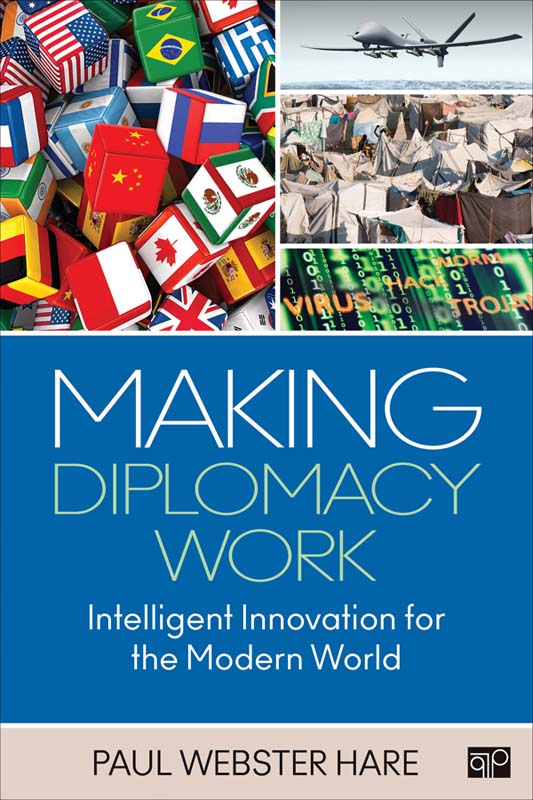
Making Diplomacy Work Making Diplomacy Work: Intelligent Innovation for the Modern World takes a fresh look at the practice of diplomacy, setting it in its contemporary context and analyzing the major factors that have changed the nature of the way it is conducted. The book is built on the premise that diplomacy must adapt some of its ritualistic and stale procedures to become more effective in the modern world. It provides a thorough examination of current issues from a diplomatic perspective and offers an extensive array of real-world examples. Author Paul Webster Hare brings 30 years of diplomacy experience to this title; it is a must-have volume for any student of diplomacy. POLITICAL SCIENCE,International Relations,General
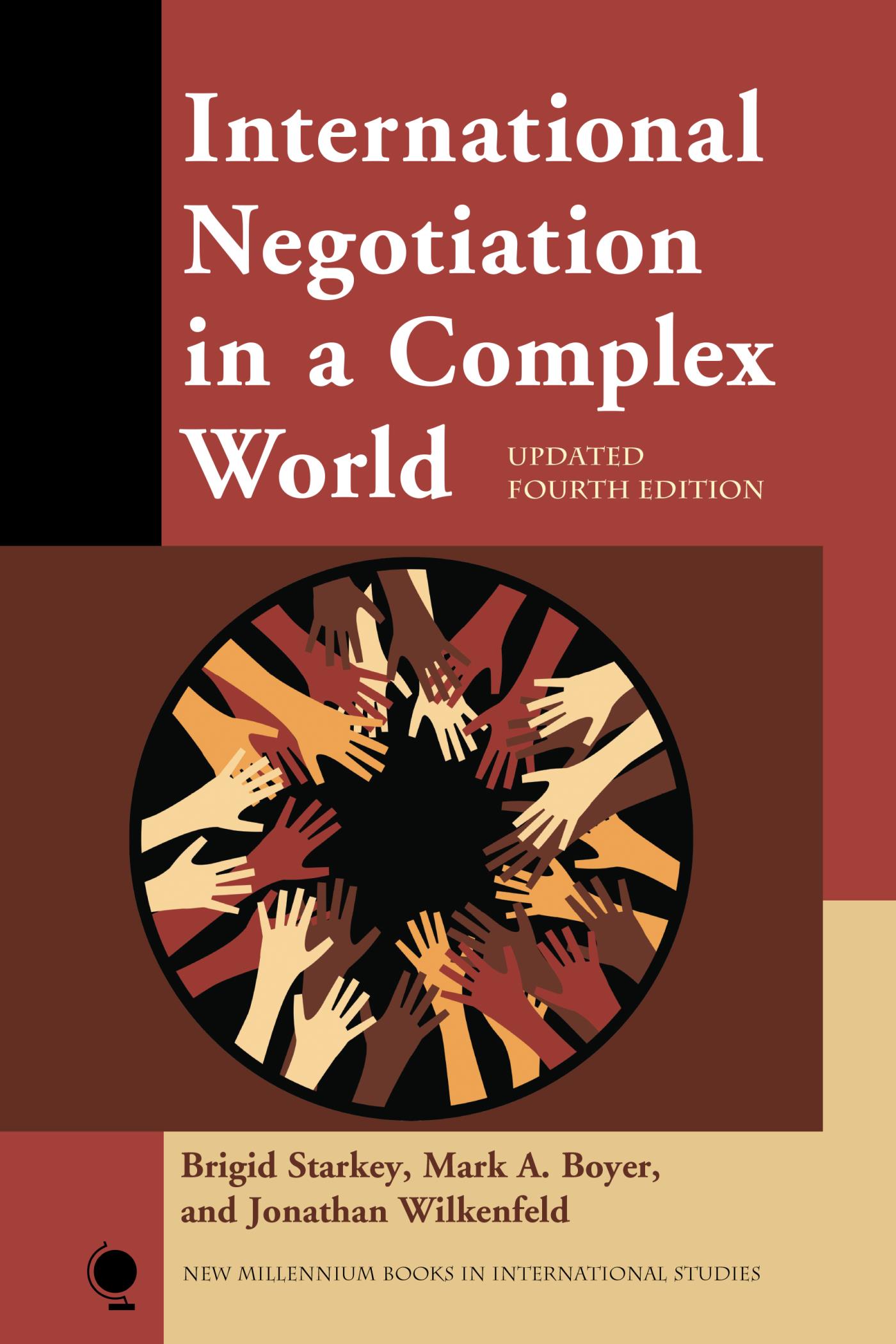
International Negotiation in a Complex World This hands-on text provides an essential introduction to international negotiation, exploring the impact of complex multilateralism on traditional negotiation concepts such as bargaining, issue salience, and strategic choice. The authors include a rich array of current real-world cases and examples—now updated with the results of the Paris climate change agreement—to illustrate key themes. POLITICAL SCIENCE,International Relations,General
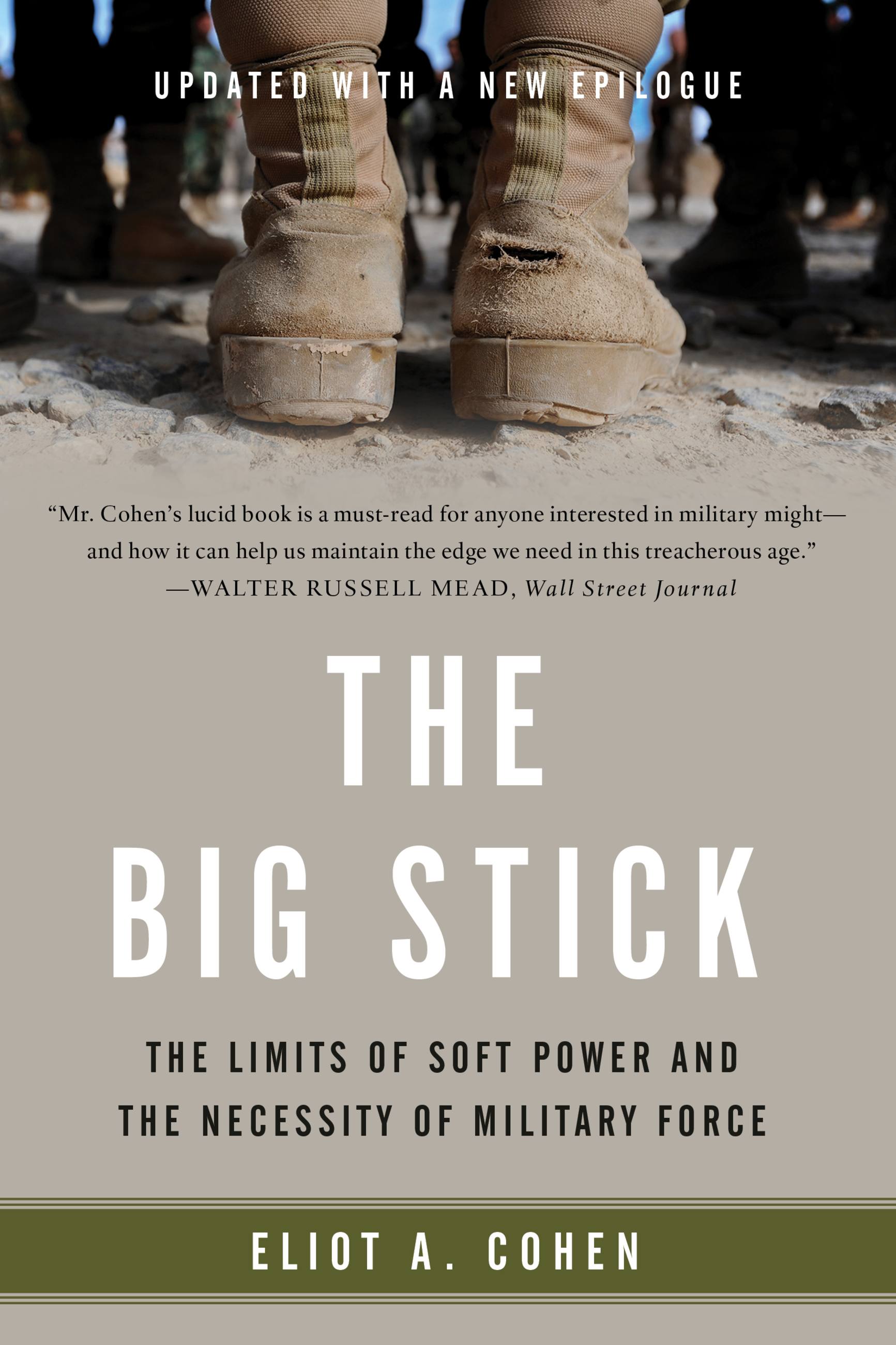
The Big Stick "Speak softly and carry a big stick" Theodore Roosevelt famously said in 1901, when the United States was emerging as a great power. It was the right sentiment, perhaps, in an age of imperial rivalry but today many Americans doubt the utility of their global military presence, thinking it outdated, unnecessary or even dangerous. In The Big Stick, Eliot A. Cohen-a scholar and practitioner of international relations-disagrees. He argues that hard power remains essential for American foreign policy. While acknowledging that the US must be careful about why, when, and how it uses force, he insists that its international role is as critical as ever, and armed force is vital to that role. Cohen explains that American leaders must learn to use hard power in new ways and for new circumstances. The rise of a well-armed China, Russia's conquest of Crimea and eastern Ukraine, nuclear threats from North Korea and Iran, and the spread of radical Islamist movements like ISIS are some of the key threats to global peace. If the United States relinquishes its position as a strong but prudent military power, and fails to accept its role as the guardian of a stable world order we run the risk of unleashing disorder, violence and tyranny on a scale not seen since the 1930s. The US is still, as Madeleine Albright once dubbed it, "the indispensable nation." POLITICAL SCIENCE,International Relations,General
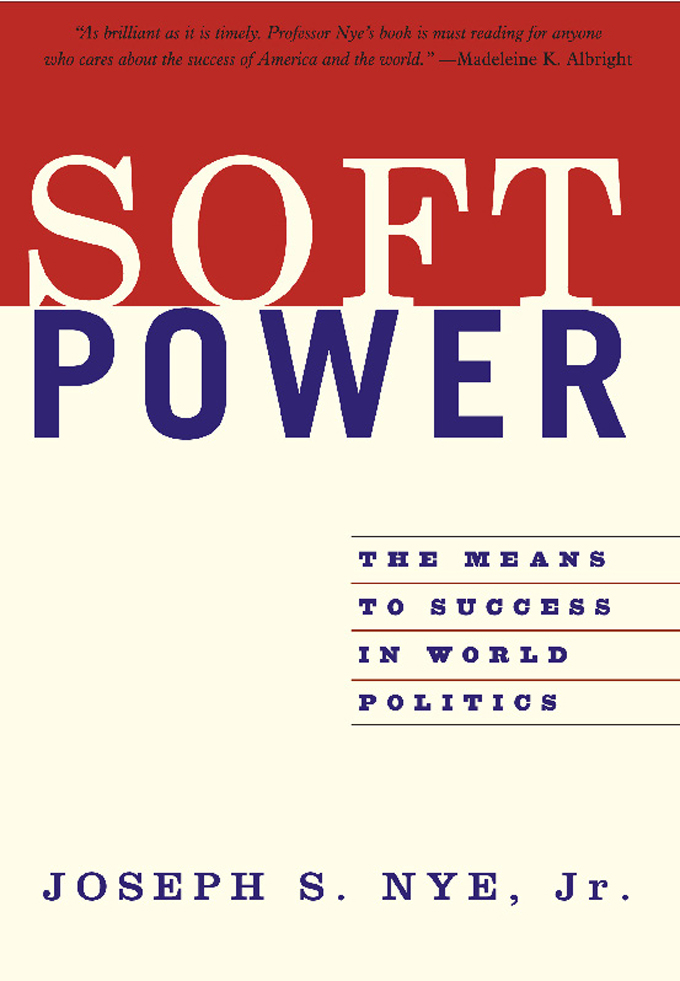
Soft Power Joseph Nye coined the term "soft power" in the late 1980s. It is now used frequently—and often incorrectly—by political leaders, editorial writers, and academics around the world. So what is soft power? Soft power lies in the ability to attract and persuade. Whereas hard power—the ability to coerce—grows out of a country's military or economic might, soft power arises from the attractiveness of a country's culture, political ideals, and policies. Hard power remains crucial in a world of states trying to guard their independence and of non-state groups willing to turn to violence. It forms the core of the Bush administration's new national security strategy. But according to Nye, the neo-conservatives who advise the president are making a major miscalculation: They focus too heavily on using America's military power to force other nations to do our will, and they pay too little heed to our soft power. It is soft power that will help prevent terrorists from recruiting supporters from among the moderate majority. And it is soft power that will help us deal with critical global issues that require multilateral cooperation among states. That is why it is so essential that America better understands and applies our soft power. This book is our guide. POLITICAL SCIENCE,International Relations,General

The Secret War Against the Jews A hugely controversial work that exposes a series of scandals from Oliver North to the British royal family, The Secret War Against the Jews reveals as much about political corruption inside Western intelligence as it does about Israel. Using thousands of previously top-secret documents and interviews with hundreds of current and former spies, Loftus and Aarons, both veteran investigators, Nazi-hunters, and authors, present a compelling narrative. The authors demonstrate that numerous Western countries, especially the United States and Great Britain, have conducted repeated and willful spying missions on Palestine and later Israel over many decades. While on the surface these two countries and others profess to be ardent allies of Israel, they work, in fact, through their intelligence services to betray Israel's secrets to the Arabs. Their motive: oil and multinational profits, which must be attained at any price through international covert policies. The pageant of characters appearing in this narrative is vast and shocking. This is not only a compelling work of history, but also a volume whose grave allegations will be debated for years to come. POLITICAL SCIENCE,International Relations,General
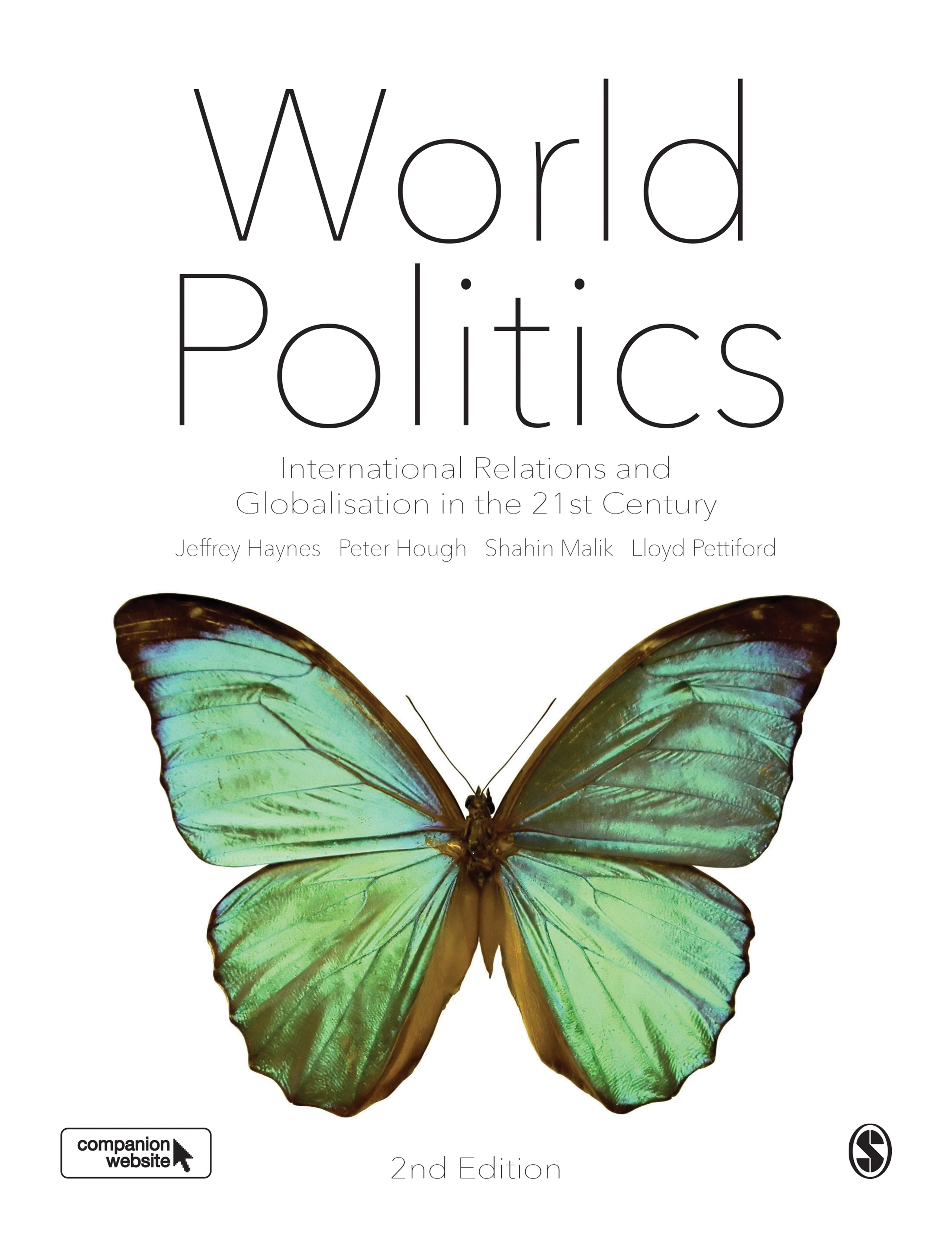
World Politics Praised for achieving significant breadth and depth of coverage of all the key themes of IR, this introduction is also full of a range of features and techniques – including a wide range of contemporary case studies and reflection boxes - to help students become adept at the subject quickly and easily POLITICAL SCIENCE,International Relations,General

International Relations Theory With 30% new content, including a new chapter on poststructuralism, this introduction now covers everything needed to accompany a student through their IR Theory module and to be a resource that they can keep coming back to throughout their studies POLITICAL SCIENCE,International Relations,General
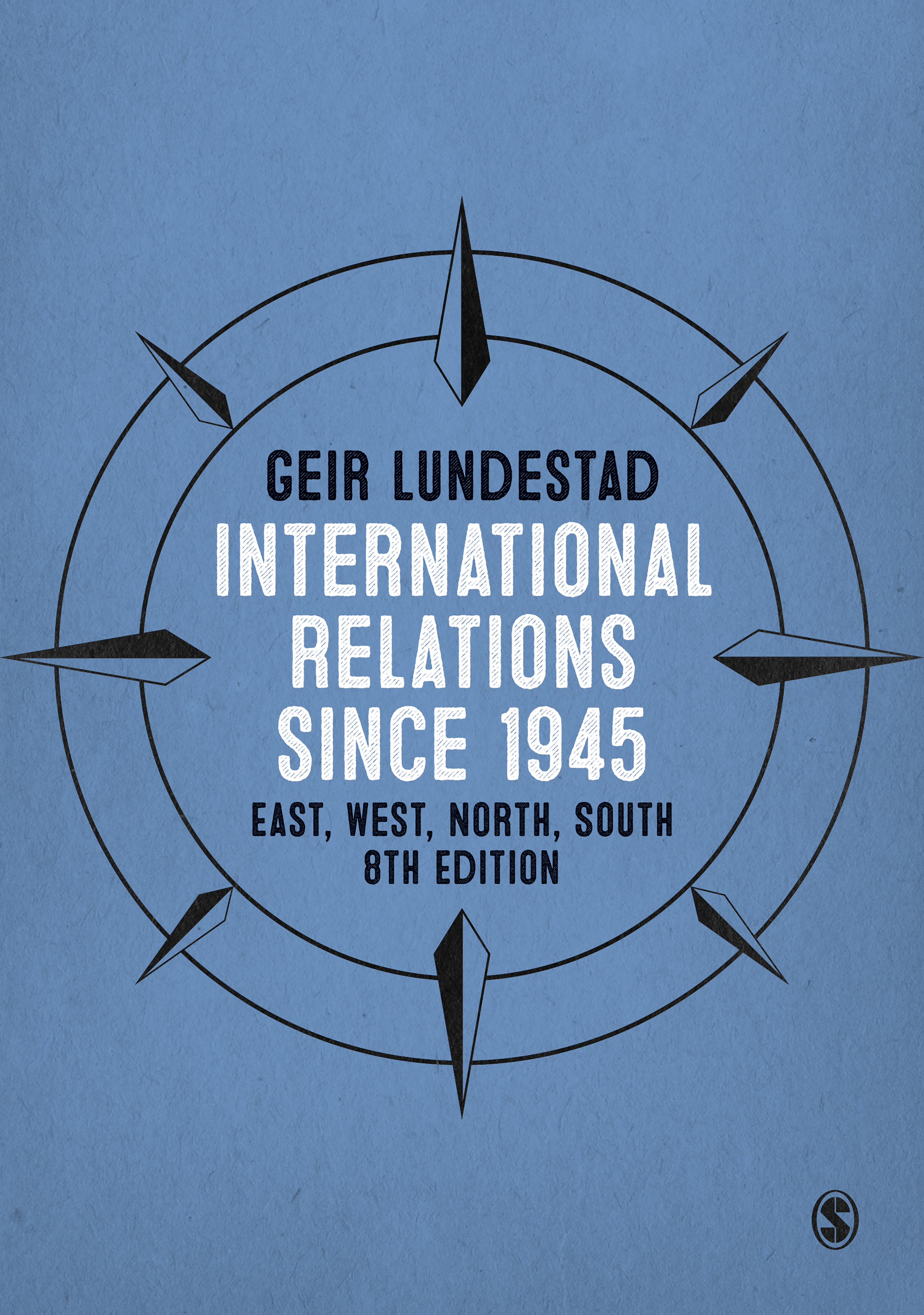
International Relations since 1945 Introducing the key events and developments in international relations, this authoritative and engaging book provides students with a clear understanding of the contemporary issues in international politics. Putting the foundations and contexts of International Relations at your fingertips, this Eighth Edition: Provides an account of the world as it has evolved up to 1945 Extended coverage of topics including population, gender and the environment Includes expanded material on the theory of international relations Includes new learning resources, including an ‘alternative perspectives’ box in each chapter Supports research with fully updated and annotated further reading lists Praised for its detail and tone, International Relations since 1945 is ideal for providing undergraduates with a historical background as they approach international relations. POLITICAL SCIENCE,International Relations,General

The UN Security Council and Human Rights The UN Charter establishes six 'principal organs'. Five of these are expressly authorized or permitted to deal with human rights. The single exception is the Security Council, but the Council has increasingly concerned itself with human rights inside sovereign states. This book recounts how this trend has developed in the Security Council, reluctantly at first but since 1989 with some enthusiasm and responsibility. Some Third-World countries are uneasy at this development, fearing that the Security Council, dominated by a single superpower, will interfere in the internal affairs of states without the agreement of the government concerned. POLITICAL SCIENCE,International Relations,General
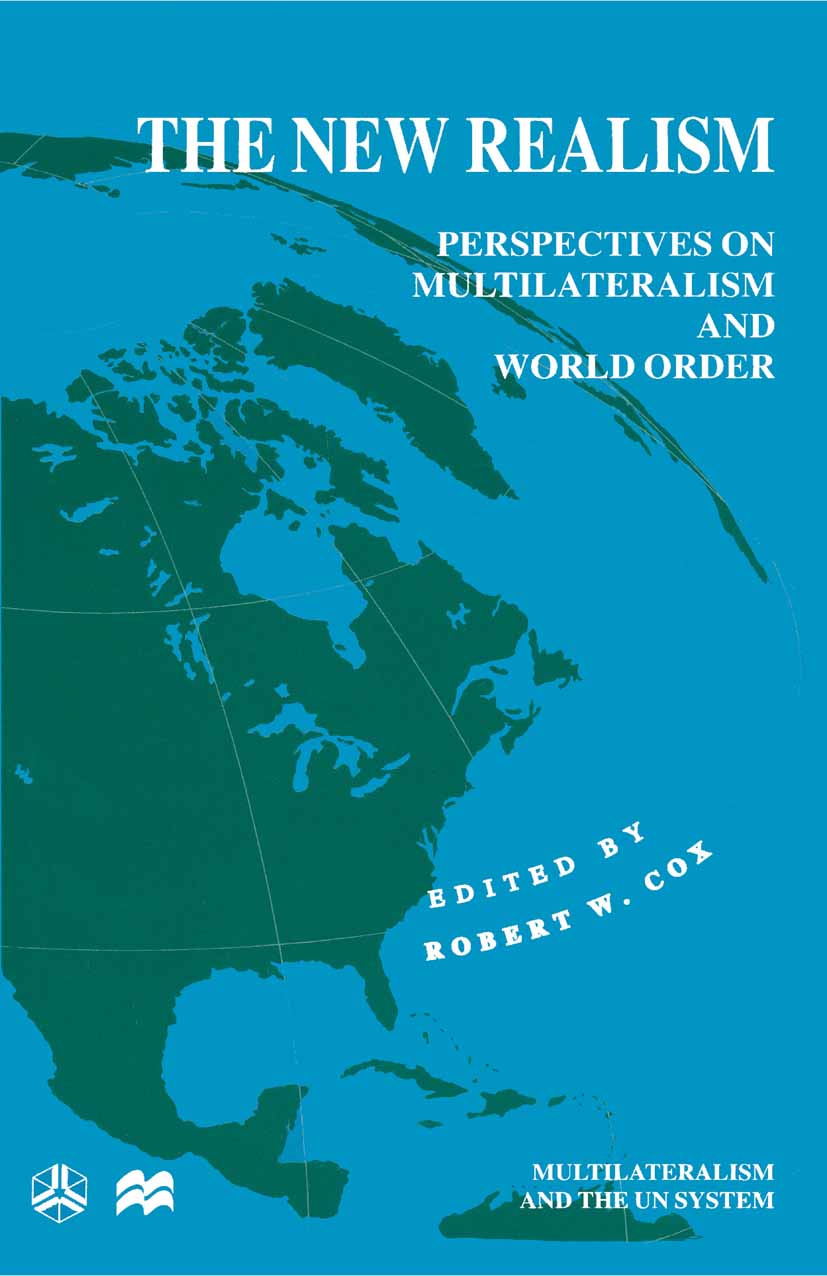
The New Realism The new realism differs from Cold War neorealism by including a broad range of non-state forces, peoples' and social movements, that challenge the exclusive dominance of states and the global economy in the making of future world order. The resurgence of civilisations brings a variety of perspectives to interpreting the present and imagining the future. Medium-term factors influence this mix of forces: the uncertainties of US policy, the fragmentation of the former Soviet Union, global social polarisation, and a new form of people-based regionalism. POLITICAL SCIENCE,International Relations,General
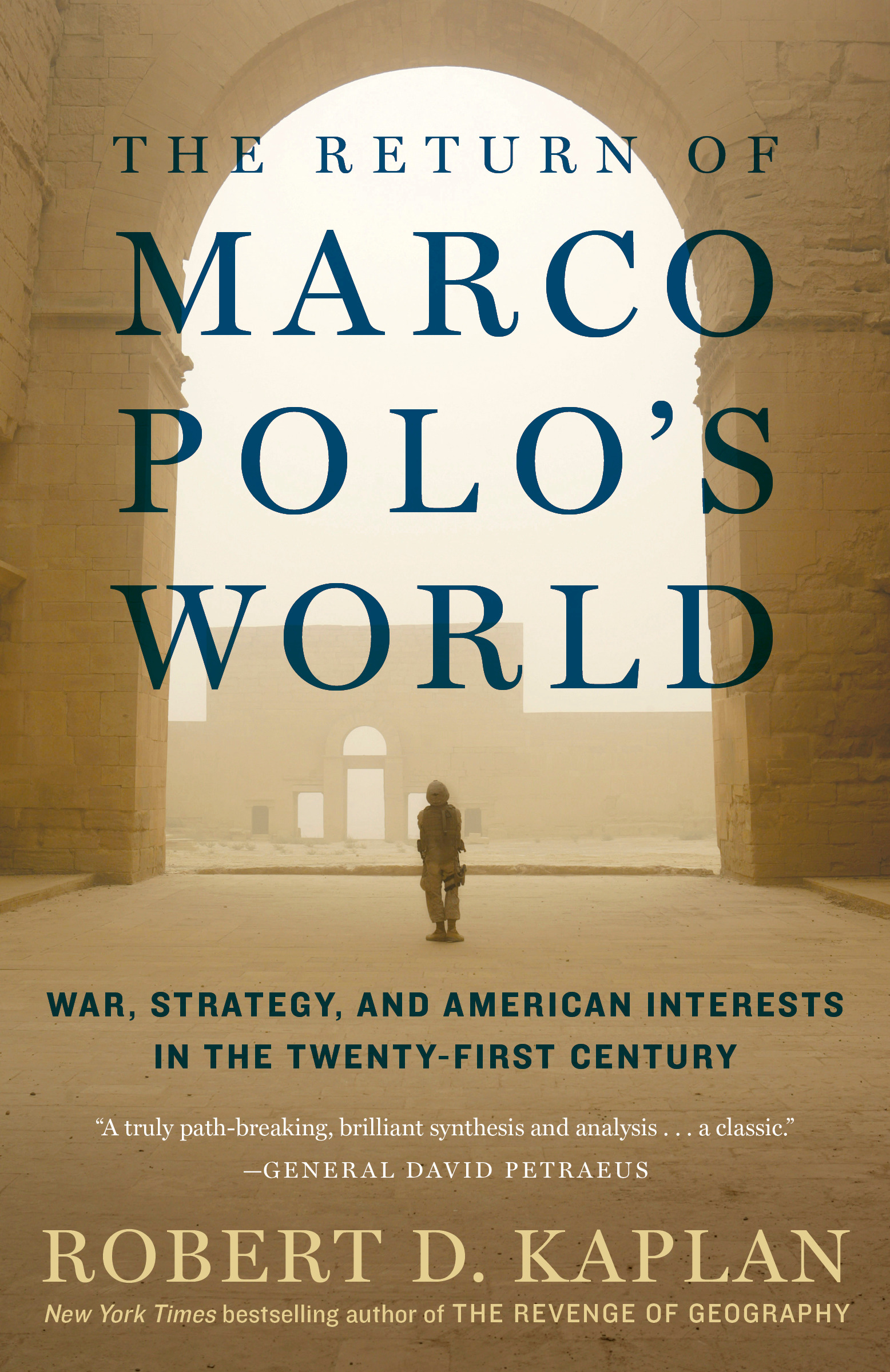
The Return of Marco Polo's World A bracing assessment of U.S. foreign policy and world disorder over the past two decades from the bestselling author of The Revenge of Geography and The Coming Anarchy “[Kaplan] has emerged not only as an eloquent defender of foreign-policy realism but as a grand strategist to whom the Pentagon turns for a tour d’horizon.”—The Wall Street Journal In the late thirteenth century, Marco Polo began a decades-long trek from Venice to China along the trade route between Europe and Asia known as the Silk Road—a foundation of Kublai Khan’s sprawling empire. Now, in the early twenty-first century, the Chinese regime has proposed a land-and-maritime Silk Road that duplicates exactly the route Marco Polo traveled. Drawing on decades of firsthand experience as a foreign correspondent and military embed for The Atlantic, Robert D. Kaplan outlines the timeless principles that should shape America’s role in a turbulent world that encompasses the Chinese challenge. From Kaplan’s immediate thoughts on President Trump to a frank examination of what will happen in the event of war with North Korea, these essays are a vigorous reckoning with the difficult choices the United States will face in the years ahead. Praise for The Return of Marco Polo’s World “Elegant and humane . . . [a] prophecy from an observer with a depressingly accurate record of predictions.”—Bret Stephens, The New York Times Book Review “These essays constitute a truly pathbreaking, brilliant synthesis and analysis of geographic, political, technological, and economic trends with far-reaching consequences. The Return of Marco Polo’s World is another work by Robert D. Kaplan that will be regarded as a classic.”—General David Petraeus (U.S. Army, Ret.) “Thoughtful, unsettling, but not apocalyptic analyses of world affairs flow steadily off the presses, and this is a superior example. . . . Presented with enough verve and insight to tempt readers to set it aside to reread in a few years.”—Kirkus Review (starred review) “An astute, powerfully stated, and bracing presentation.”—Booklist “This volume compiles sixteen major essays on America’s foreign policy from national security commentator Kaplan. . . . An overview of thoughtful, multilayered positions and perspectives evolving through changing circumstances.”—Publishers Weekly POLITICAL SCIENCE,International Relations,General
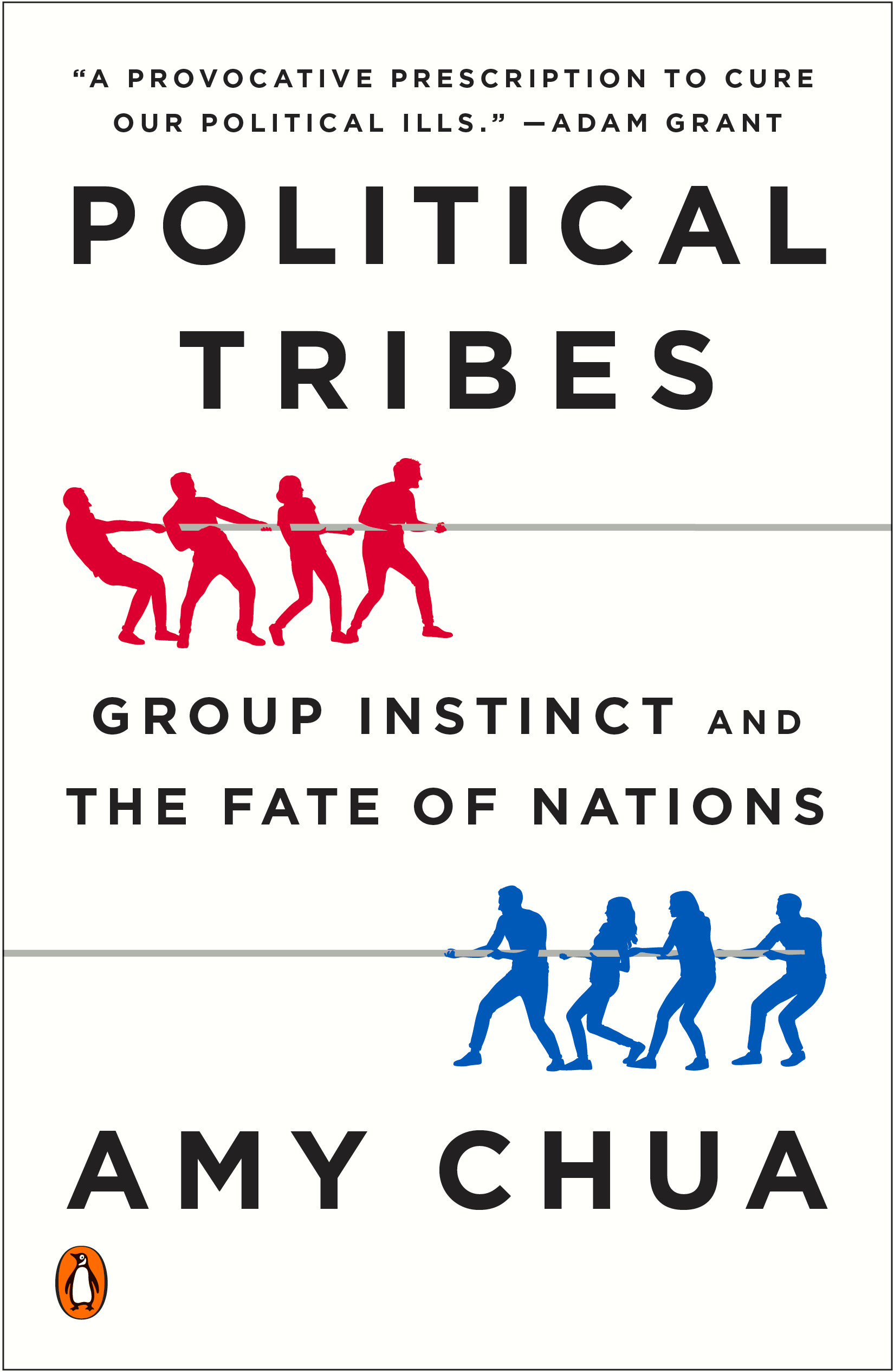
Political Tribes The bestselling author of Battle Hymn of the Tiger Mother, Yale Law School Professor Amy Chua offers a bold new prescription for reversing our foreign policy failures and overcoming our destructive political tribalism at home Humans are tribal. We need to belong to groups. In many parts of the world, the group identities that matter most – the ones that people will kill and die for – are ethnic, religious, sectarian, or clan-based. But because America tends to see the world in terms of nation-states engaged in great ideological battles – Capitalism vs. Communism, Democracy vs. Authoritarianism, the “Free World” vs. the “Axis of Evil” – we are often spectacularly blind to the power of tribal politics. Time and again this blindness has undermined American foreign policy. In the Vietnam War, viewing the conflict through Cold War blinders, we never saw that most of Vietnam’s “capitalists” were members of the hated Chinese minority. Every pro-free-market move we made helped turn the Vietnamese people against us. In Iraq, we were stunningly dismissive of the hatred between that country’s Sunnis and Shias. If we want to get our foreign policy right – so as to not be perpetually caught off guard and fighting unwinnable wars – the United States has to come to grips with political tribalism abroad. Just as Washington’s foreign policy establishment has been blind to the power of tribal politics outside the country, so too have American political elites been oblivious to the group identities that matter most to ordinary Americans – and that are tearing the United States apart. As the stunning rise of Donald Trump laid bare, identity politics have seized both the American left and right in an especially dangerous, racially inflected way. In America today, every group feels threatened: whites and blacks, Latinos and Asians, men and women, liberals and conservatives, and so on. There is a pervasive sense of collective persecution and discrimination. On the left, this has given rise to increasingly radical and exclusionary rhetoric of privilege and cultural appropriation. On the right, it has fueled a disturbing rise in xenophobia and white nationalism. In characteristically persuasive style, Amy Chua argues that America must rediscover a national identity that transcends our political tribes. Enough false slogans of unity, which are just another form of divisiveness. It is time for a more difficult unity that acknowledges the reality of group differences and fights the deep inequities that divide us. POLITICAL SCIENCE,International Relations,General
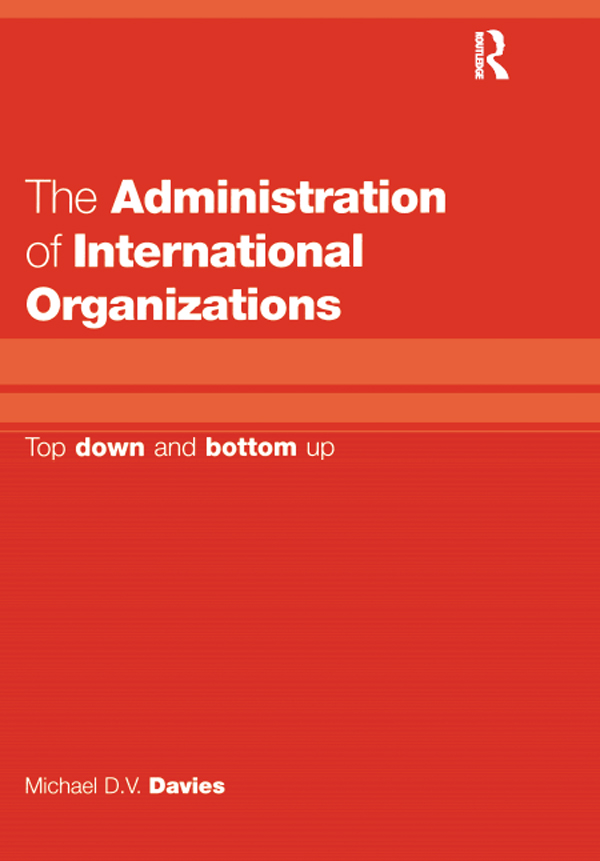
The Administration of International Organizations Drawing on his extensive practical experience as an international civil servant in a number of organizations, Davies writes in a lively and readable manner about all aspects of administrative policy and its related implications. Divided into two parts, the first - Top down - will enable policy makers in government, academia and elsewhere who have an interest in the proper governance and management of international institutions to gain fresh insight into the topic. The second part - Bottom up - provides a substantial body of knowledge of administrations, including case studies of best and worse practice. The book includes analysis of: -The UN system -International Financial Institutions -Co-ordinated Organizations -Regional European Institutions -The Consultative Group for International Agricultural Research This is a work that fills a well-defined gap in organizational knowledge in a rigorous, but accessible way. It is essential reading for both practitioners and academics involved with international organizations. POLITICAL SCIENCE,International Relations,General
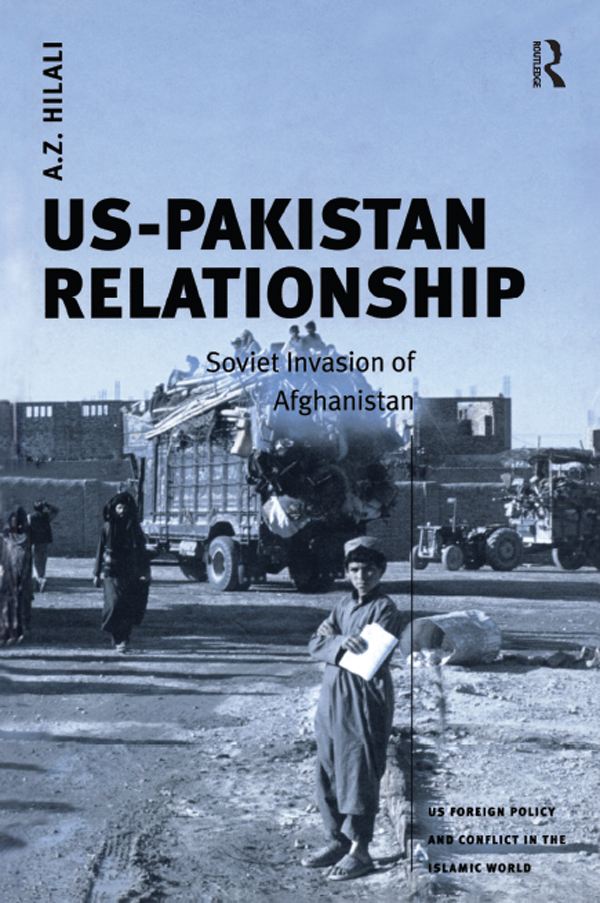
US-Pakistan Relationship Hilali provides an excellent study into the US-Pakistan partnership under the Reagan administration. The book explores the causes of Pakistan's involvement in the Afghanistan war and the United States' support to prevent Soviet adventurism. It shows that Pakistan was the principal channel through which assistance was provided to Afghan freedom fighters; it also provided access to its military bases to use against the Soviet Union. The study looks at the consequences of the war on Pakistan and explains how it became enmeshed within its domestic politics. Furthermore, it evaluates the role of Pakistan as a key partner in the global coalition against terrorism and discusses how General Pervez Musharraf brought about Pakistan's development towards a progressive, moderate and democratic society. Ideally suited to courses on foreign policy. POLITICAL SCIENCE,International Relations,General
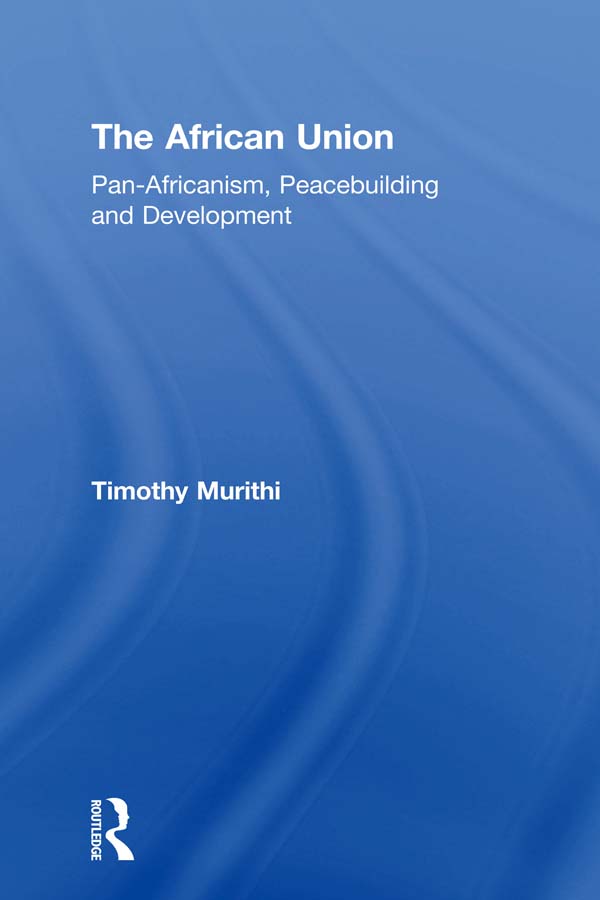
The African Union The African Union was established in July 2002 by African leaders, evolving from the Organization of African Unity (OAU). However the idea of the African Union can be traced to the Pan-Africanist movement. Timothy Murithi looks at the emergence of Pan-Africanism and how it was institutionalized through the Pan-African Congress and the OAU. He argues that the African Union represents the third phase of the institutionalization of Pan-Africanism. The book examines the limitations of the OAU and discusses whether the African Union can adopt a more interventionist stance in dealing with peacebuilding and development in Africa. The volume assesses the African Union's peace and security institutions and analyzes how it is beginning to collaborate with civil society. It takes a critical look at the Union's New Partnership for Africa's Development (NEPAD) and argues that Africa needs to adopt a developmental and governance agenda that will be much more responsive towards improving the well-being and livelihood of its peoples. POLITICAL SCIENCE,International Relations,General
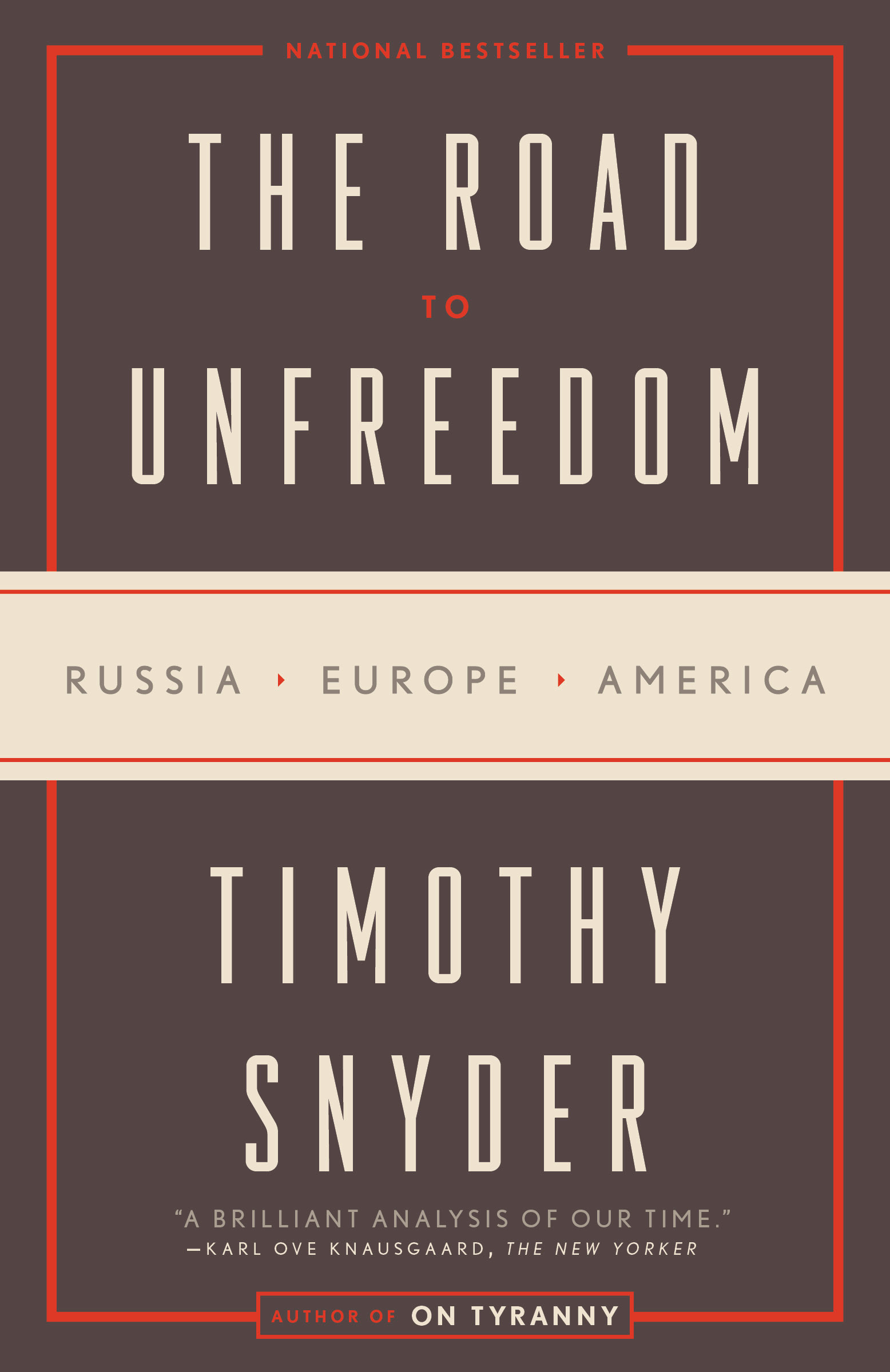
The Road to Unfreedom NEW YORK TIMES BESTSELLER • From the author of On Tyranny comes a stunning new chronicle of the rise of authoritarianism from Russia to Europe and America. “A brilliant analysis of our time.”—Karl Ove Knausgaard, The New Yorker With the end of the Cold War, the victory of liberal democracy seemed final. Observers declared the end of history, confident in a peaceful, globalized future. This faith was misplaced. Authoritarianism returned to Russia, as Putin found fascist ideas that could be used to justify rule by the wealthy. In the 2010s, it has spread from east to west, aided by Russian warfare in Ukraine and cyberwar in Europe and the United States. Russia found allies among nationalists, oligarchs, and radicals everywhere, and its drive to dissolve Western institutions, states, and values found resonance within the West itself. The rise of populism, the British vote against the EU, and the election of Donald Trump were all Russian goals, but their achievement reveals the vulnerability of Western societies. In this forceful and unsparing work of contemporary history, based on vast research as well as personal reporting, Snyder goes beyond the headlines to expose the true nature of the threat to democracy and law. To understand the challenge is to see, and perhaps renew, the fundamental political virtues offered by tradition and demanded by the future. By revealing the stark choices before us--between equality or oligarchy, individuality or totality, truth and falsehood--Snyder restores our understanding of the basis of our way of life, offering a way forward in a time of terrible uncertainty. POLITICAL SCIENCE,International Relations,General
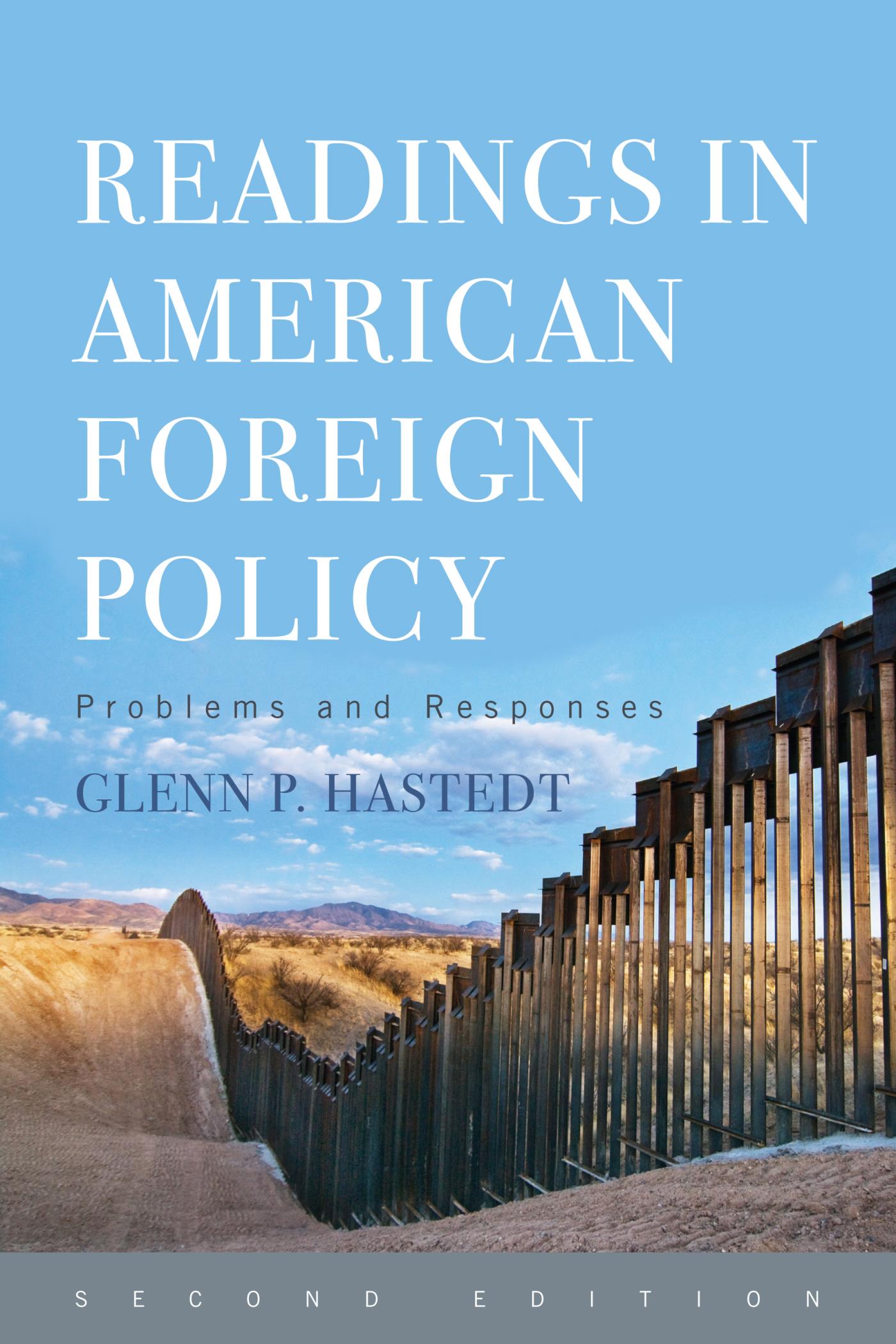
Readings in American Foreign Policy Comprised of the most recent journal articles, government documents, and think tank pieces, Readings in American Foreign Policy looks at contemporary problems and responses to U.S. foreign policy around the world. POLITICAL SCIENCE,International Relations,General
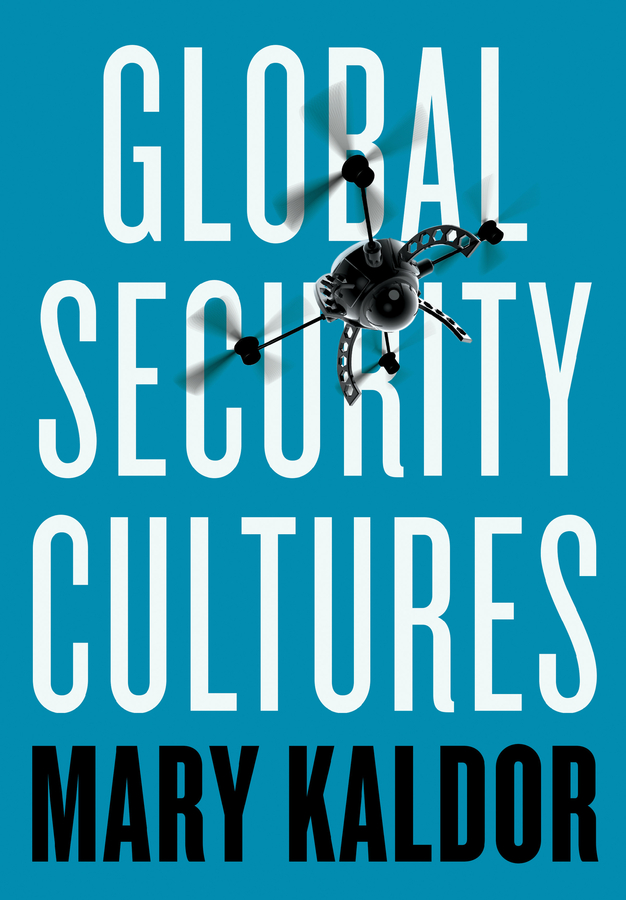
Global Security Cultures Why do politicians think that war is the answer to terror when military intervention in Iraq, Afghanistan, Pakistan, Syria, Mali, Somalia and elsewhere has made things worse? Why do some conflicts never end? And how is it that practices like beheadings, extra-judicial killings, the bombing of hospitals and schools and sexual slavery are becoming increasingly common? In this book, renowned scholar of war and human security Mary Kaldor introduces the concept of global security cultures in order to explain why we get stuck in particular pathways to security. A global security culture, she explains, involves different combinations of ideas, narratives, rules, people, tools, practices and infrastructure embedded in a specific form of political authority, a set of power relations, that come together to address or engage in large-scale violence. In contrast to the Cold War period, when there was one dominant culture based on military forces and nation-states, nowadays there are competing global security cultures. Defining four main types - geo-politics, new wars, the liberal peace, and the war on terror she investigates how we might identify contradictions, dilemmas and experiments in contemporary security cultures that might ultimately open up new pathways to rescue and safeguard civility in the future. POLITICAL SCIENCE,International Relations,General
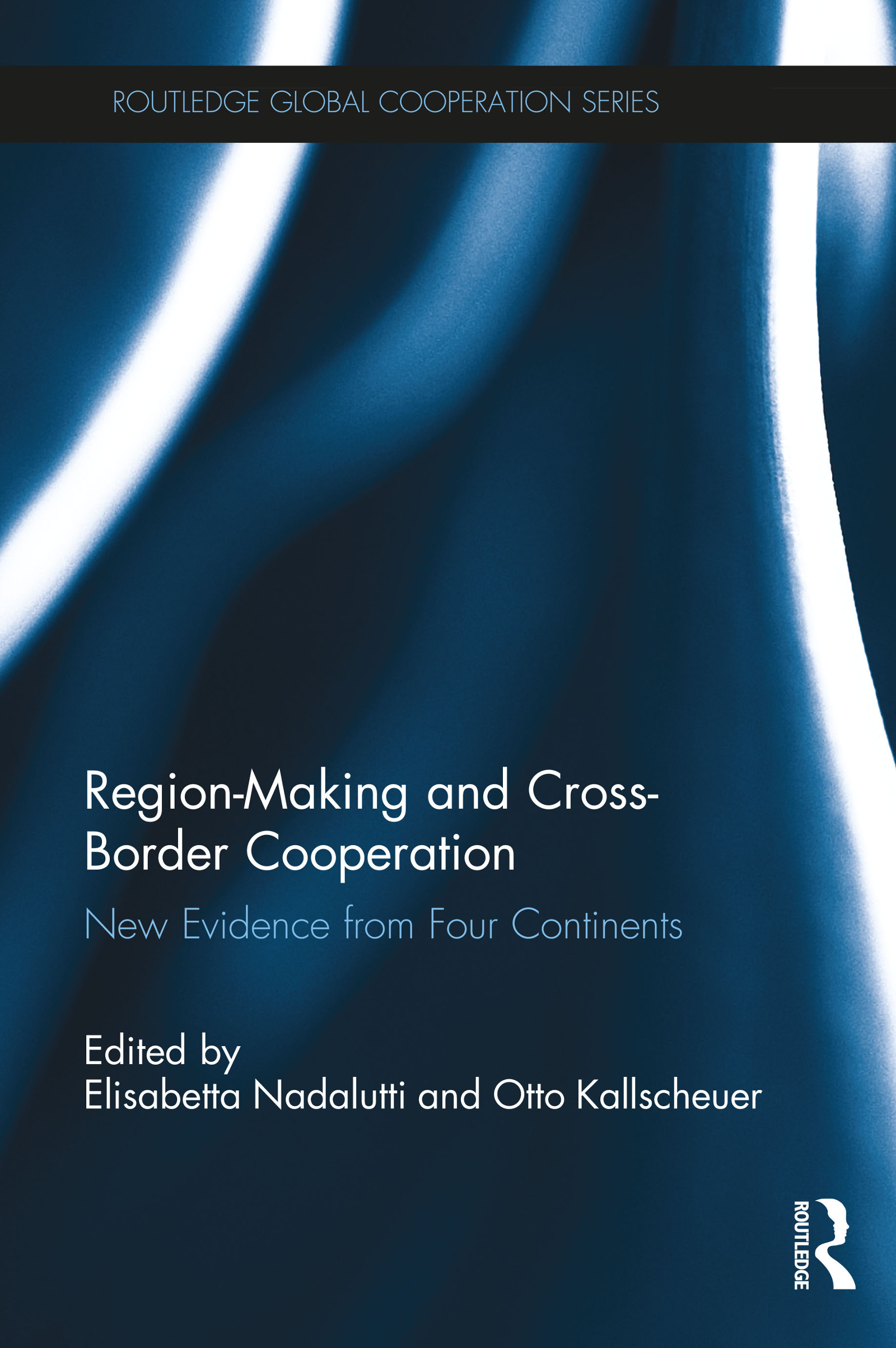
Region-Making and Cross-Border Cooperation This book explores the nature of regions and how they function, particularly at the local and micro-level. Whilst recent years have seen a resurgence in debates around the roles which regions can play in development, the focus has tended to be on 'macro' regional institutions such as the EU, ASEAN, ECOWAS or MERCOSUR. In contrast, this book offers a nuanced analysis of the important field of sub-regionalism and sub-national cross-border cooperation. Region-Making and Cross-Border Cooperation takes a fresh look at both theoretical and empirical approaches to ‘region-making’ through cooperation activities at the micro-level across national borders in Europe, Southeast Asia, Latin America, Africa and the Middle East. The book aims to explore the role that institutional dynamics play at the micro-level in shaping local and global ties, investigate what the formal and informal integration factors are that bolster regionalism and regionalization processes, and to clarify to what extent, and under what conditions, cooperation at the micro-level can be instrumental to solving common problems. Scholars and students within politics, sociology, geography, and economics would find this book an important guide to regionalism at a micro-local level perspective. POLITICAL SCIENCE,International Relations,General

Introduction to International Relations This clear and concise text introduces the theoretical frameworks that form the foundation of international relations. Using levels of analysis as the primary unifying force, Kaufman also assesses what traditional approaches can’t explain about the contemporary international system. POLITICAL SCIENCE,International Relations,General

Bilateral Cooperation and Human Trafficking This book presents a case study of human trafficking from Nigeria to the UK, with a focus on practical measures for ending this trafficking. The study addresses the many aspects of human trafficking, including sexual exploitation, domestic servitude, labor exploitation, benefit fraud, and organ harvesting. Despite the huge investment of the international community to eradicate it, this form of modern day slavery continues, and the author urges stakeholders to focus not only on criminals but also on attitudes, cultures, laws and policies that hinder the eradication of modern slavery. POLITICAL SCIENCE,International Relations,General
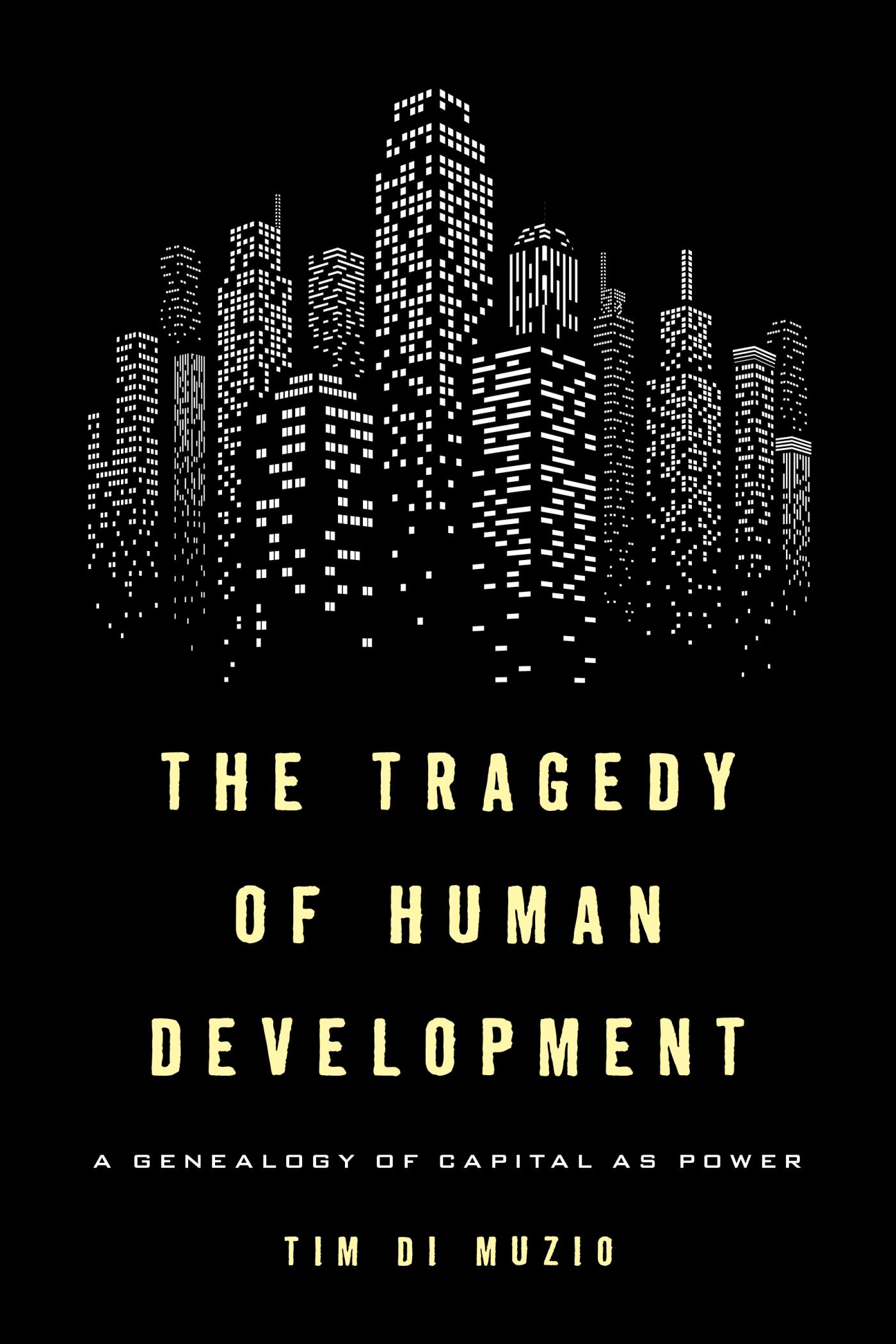
The Tragedy of Human Development Exploring key moments in the historical development of humanity, this book conceives of human development as a dramatic tragedy. It examines avoidable sufferings in our history, considering the reasons why these sufferings were inflicted and enabled when they appear – from a certain angle – to be unnecessary. POLITICAL SCIENCE,International Relations,General
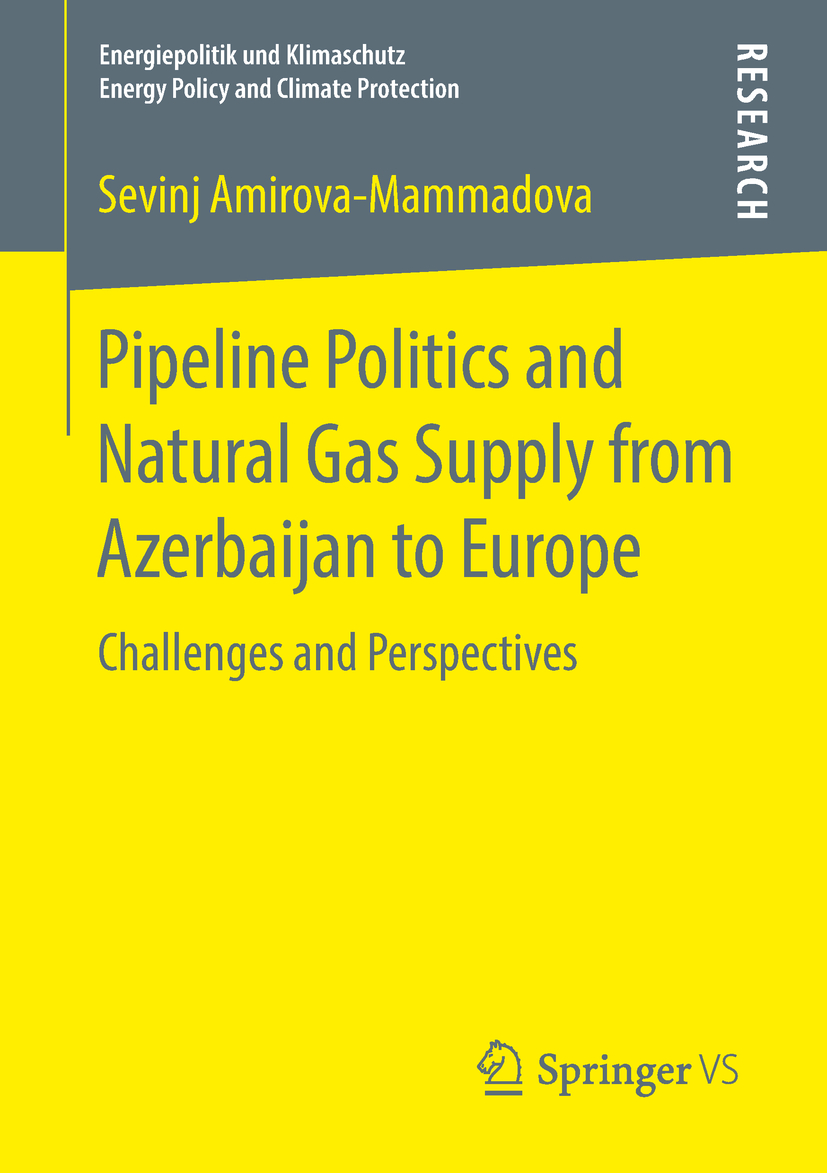
Pipeline Politics and Natural Gas Supply from Azerbaijan to Europe Sevinj Amirova-Mammadova explores pipeline dynamics and natural gas supply within the southern gas corridor and provides an analysis of how policy interests and decisions of the state actors affect the current energy politics in the Caspian region. The research period covers the second stage of the Caspian energy development determined by the production and export of natural gas to the European markets. The focal point of the policy analysis lies on the competition among the different pipeline projects, namely NABUCCO, ITGI, TAP, SEEP, and the decisionâ€making process of the export route selection. Energy interests of Turkey, Russia, and Azerbaijan elaborated in the research explain how and why certain decisions have been made by these major regional actors. POLITICAL SCIENCE,International Relations,General

Building Your IR Theory Toolbox This concise text provides a balanced introduction to international relations theory. An invaluable resource for teaching theory to undergraduates, it brings together a wide range of perspectives—including realism, liberalism, Marxism, social constructivism, feminism, and post-modernism—in a single comprehensive and easily readable text. POLITICAL SCIENCE,International Relations,General
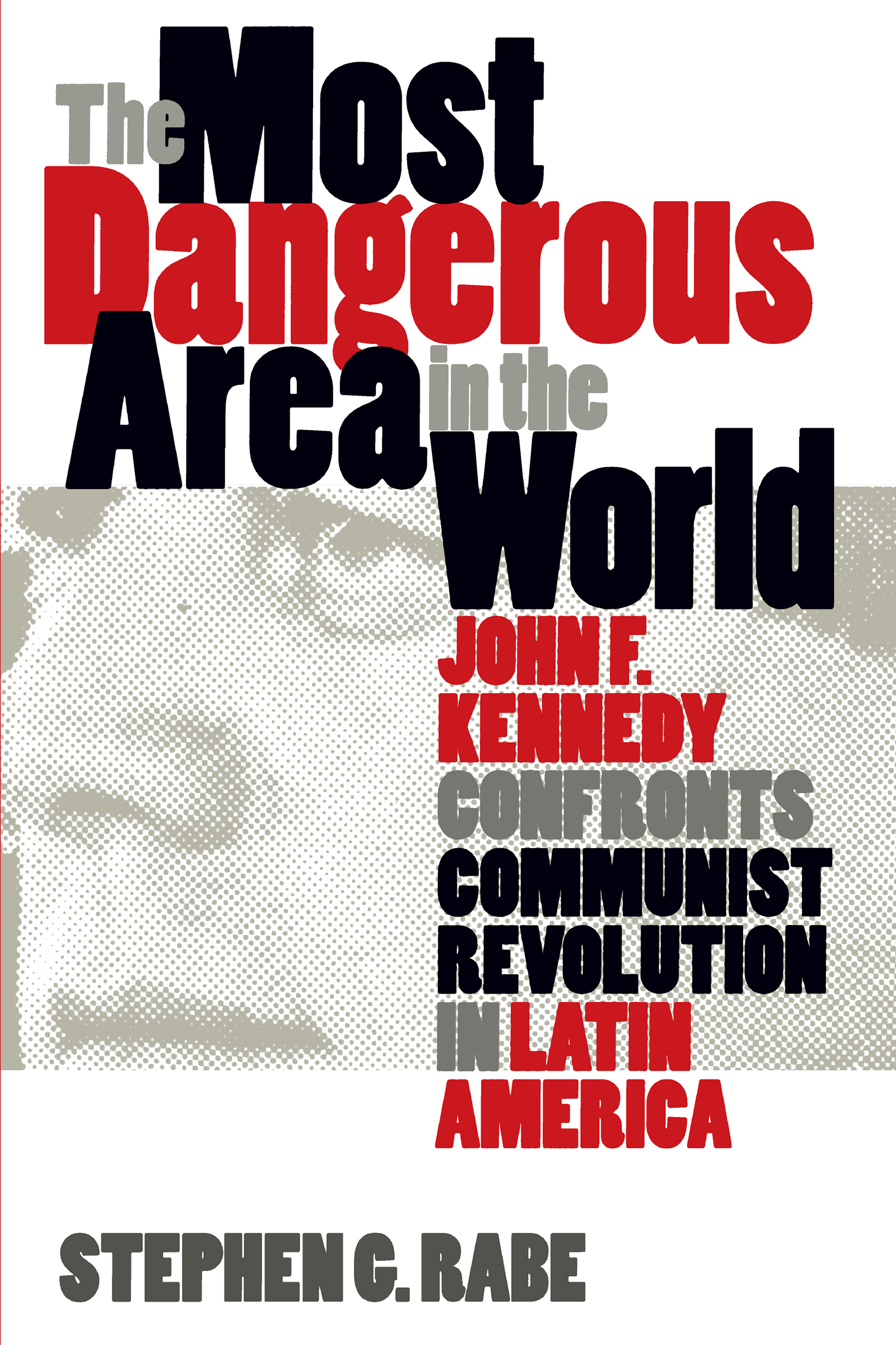
The Most Dangerous Area in the World In March 1961, President John F. Kennedy announced the formation of the Alliance for Progress, a program dedicated to creating prosperous, socially just, democratic societies throughout Latin America. Over the next few years, the United States spent nearly $20 billion in pursuit of the Alliance's goals, but Latin American economies barely grew, Latin American societies remained inequitable, and sixteen extraconstitutional changes of government rocked the region. In this close, critical analysis, Stephen Rabe explains why Kennedy's grand plan for Latin America proved such a signal policy failure.Drawing on recently declassified materials, Rabe investigates the nature of Kennedy's intense anti-Communist crusade and explores the convictions that drove him to fight the Cold War throughout the Caribbean and Latin America--a region he repeatedly referred to as "the most dangerous area in the world." As Rabe acknowledges, Kennedy remains popular in the United States and Latin America, in part for the noble purposes behind the Alliance for Progress. But an unwavering determination to wage Cold War led Kennedy to compromise, even mutilate, those grand goals. POLITICAL SCIENCE,International Relations,General
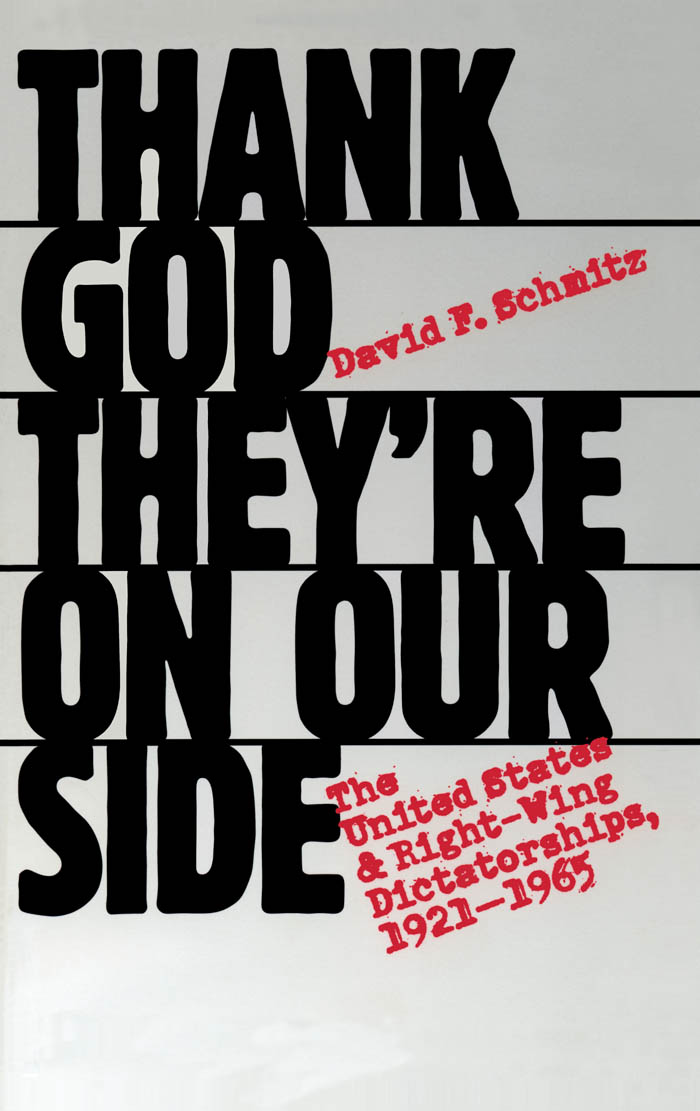
Thank God They're on Our Side Despite its avowed commitment to liberalism and democracy internationally, the United States has frequently chosen to back repressive or authoritarian regimes in parts of the world. In this comprehensive examination of American support of right-wing dictatorships, David Schmitz challenges the contention that the democratic impulse has consistently motivated U.S. foreign policy.Compelled by a persistent concern for order and influenced by a paternalistic racism that characterized non-Western peoples as vulnerable to radical ideas, U.S. policymakers viewed authoritarian regimes as the only vehicles for maintaining political stability and encouraging economic growth in nations such as Nicaragua and Iran, Schmitz argues. Expediency overcame ideology, he says, and the United States gained useful--albeit brutal and corrupt--allies who supported American policies and provided a favorable atmosphere for U.S. trade. But such policy was not without its critics and did not remain static, Schmitz notes. Instead, its influence waxed and waned over the course of five decades, until the U.S. interventions in Vietnam marked its culmination. POLITICAL SCIENCE,International Relations,General
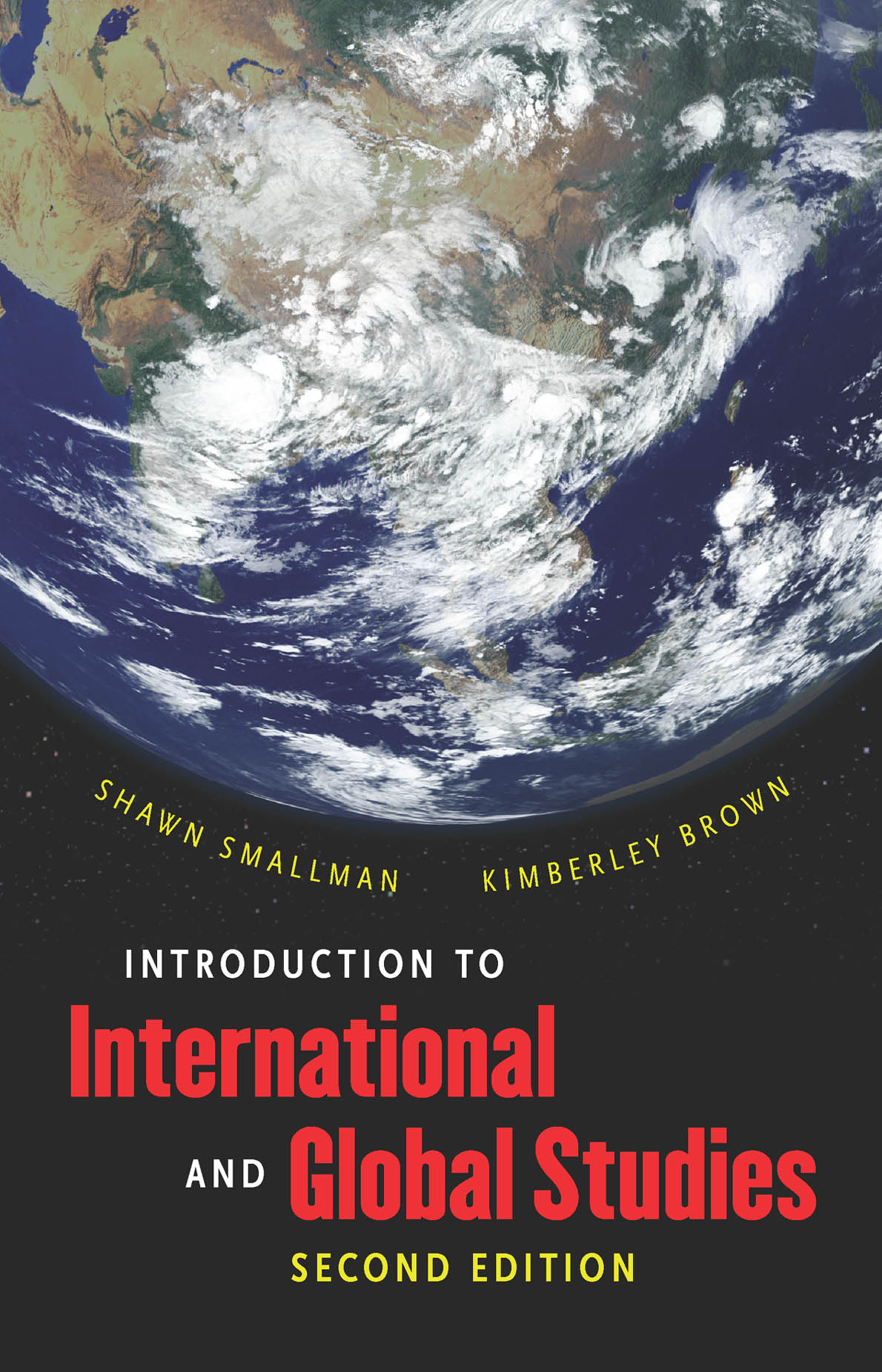
Introduction to International and Global Studies, Second Edition This innovative introduction to international and global studies, updated and revised in a new edition, offers instructors in the social sciences and humanities a core textbook for teaching undergraduates in this rapidly growing field. Encompassing the latest scholarship in what is a markedly interdisciplinary endeavor, Shawn Smallman and Kimberley Brown introduce key concepts, themes, and issues and then examine each in lively chapters on essential topics that include the history of globalization; economic, political, and cultural globalization; security, energy, and development; health; agriculture and food; and the environment. Within these topics, the authors explore such timely and pressing subjects as commodity chains, labor (including present-day slavery), human rights, multinational corporations, and the connections among them. New to this edition: * The latest research on debates over privacy rights and surveillance since Edward Snowden's disclosures* Updates on significant political and economic developments throughout the world, including a new case study of European Union, Icelandic, and Greek responses to the 2008 fiscal crisis* The newest information about the rise of fracking, the Fukushima nuclear disaster, the decline of the Peak Oil movement, and climate change, including the latter's effects on the Arctic and Antarctica* A dedicated website with authors' blog and a teaching tab with syllabi, class activities, and well-designed, classroom-tested resources* An updated teacher's manual available online, including sample examination questions, additional resources for each chapter, and special assistance for teaching ESL students * Updated career advice for international studies majors POLITICAL SCIENCE,International Relations,General
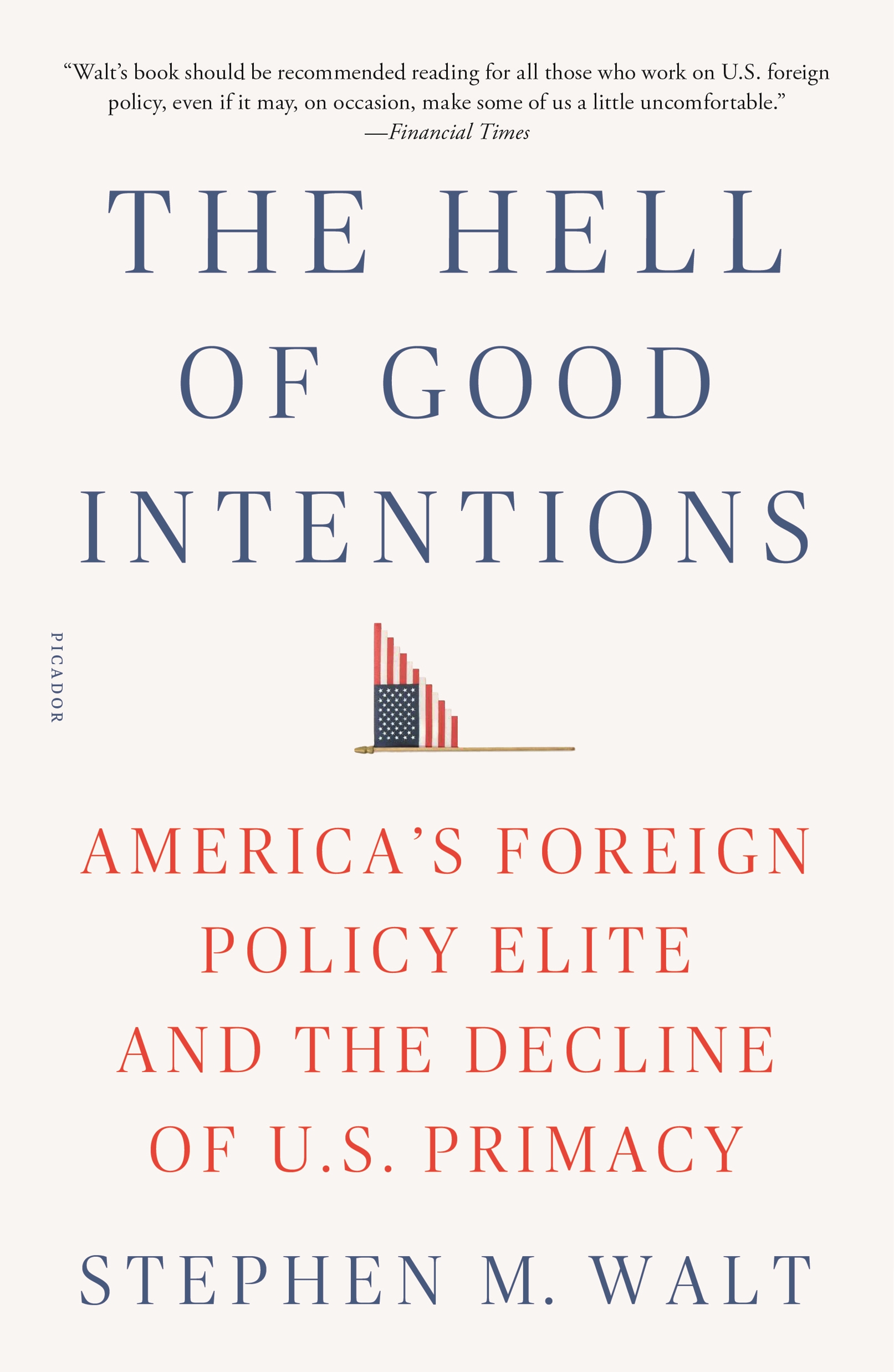
The Hell of Good Intentions From the New York Times–bestselling author Stephen M. Walt, The Hell of Good Intentions dissects the faults and foibles of recent American foreign policy—explaining why it has been plagued by disasters like the “forever wars†in Iraq and Afghanistan and outlining what can be done to fix it. In 1992, the United States stood at the pinnacle of world power and Americans were confident that a new era of peace and prosperity was at hand. Twenty-five years later, those hopes have been dashed. Relations with Russia and China have soured, the European Union is wobbling, nationalism and populism are on the rise, and the United States is stuck in costly and pointless wars that have squandered trillions of dollars and undermined its influence around the world. The root of this dismal record, Walt argues, is the American foreign policy establishment’s stubborn commitment to a strategy of “liberal hegemony.†Since the end of the Cold War, Republicans and Democrats alike have tried to use U.S. power to spread democracy, open markets, and other liberal values into every nook and cranny of the planet. This strategy was doomed to fail, but its proponents in the foreign policy elite were never held accountable and kept repeating the same mistakes. Donald Trump won the presidency promising to end the misguided policies of the foreign policy “Blob†and to pursue a wiser approach. But his erratic and impulsive style of governing, combined with a deeply flawed understanding of world politics, are making a bad situation worse. The best alternative, Walt argues, is a return to the realist strategy of “offshore balancing,†which eschews regime change, nation-building, and other forms of global social engineering. The American people would surely welcome a more restrained foreign policy, one that allowed greater attention to problems here at home. This long-overdue shift will require abandoning the futile quest for liberal hegemony and building a foreign policy establishment with a more realistic view of American power. Clear-eyed, candid, and elegantly written, Stephen M. Walt’s The Hell of Good Intentions offers both a compelling diagnosis of America’s recent foreign policy follies and a proven formula for renewed success. POLITICAL SCIENCE,International Relations,General

A Political History of the World A three-thousand year history of the world that examines the causes of war and the search for peace In three thousand years of history, China has spent at least eleven centuries at war. The Roman Empire was in conflict during at least 50 per cent of its lifetime. Since 1776, the United States has spent over one hundred years at war. The dream of peace has been universal in the history of humanity. So why have we so rarely been able to achieve it? In A Political History of the World, Jonathan Holslag has produced a sweeping history of the world, from the Iron Age to the present, that investigates the causes of conflict between empires, nations and peoples and the attempts at diplomacy and cosmopolitanism. A birds-eye view of three thousand years of history, the book illuminates the forces shaping world politics from Ancient Egypt to the Han Dynasty, the Pax Romana to the rise of Islam, the Peace of Westphalia to the creation of the United Nations. This truly global approach enables Holslag to search for patterns across different eras and regions, and explore larger questions about war, diplomacy, and power. Has trade fostered peace? What are the limits of diplomacy? How does environmental change affect stability? Is war a universal sin of power? At a time when the threat of nuclear war looms again, this is a much-needed history intended for students of international politics, and anyone looking for a background on current events. POLITICAL SCIENCE,International Relations,General
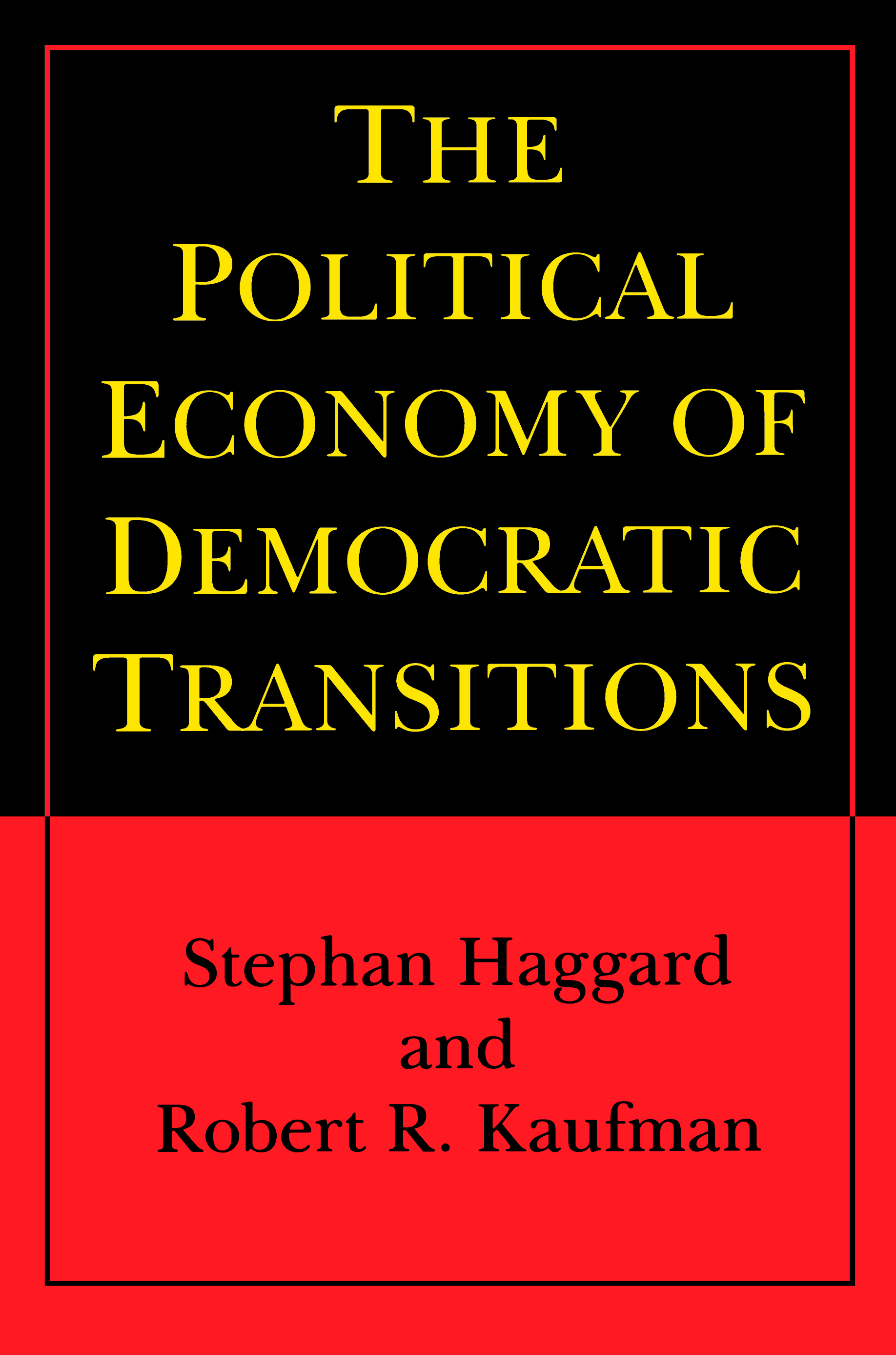
The Political Economy of Democratic Transitions In the last two decades, there has been a widespread movement from authoritarian to democratic rule among developing countries, often occurring against a backdrop of severe economic crises and the adoption of market-oriented reforms. The coincidence of these events raises long-standing questions about the relationship between economic and political change. In this book, Stephan Haggard and Robert Kaufman explore this relationship, addressing a variety of questions: What role have economic crises played in the current wave of political liberalization and democratization? Can new democracies manage the daunting political challenges posed by economic reform? Under what economic and institutional conditions is democracy most likely to be consolidated? Drawing on contemporary political economy and the experiences of twelve Latin American and Asian countries, they develop a new approach to understanding democratic transitions. Haggard and Kaufman first analyze the relationship between economic crisis and authoritarian withdrawal and then examine how the economic and institutional legacies of authoritarian rule affect the capacity of new democratic governments to initiate and sustain economic policy reform. Finally, the authors analyze the consolidation of political and economic reform over the long run. Throughout, they emphasize the relationship between economic conditions, the interests and power of contending social groups, and the mediating role of representative institutions, particularly political parties. POLITICAL SCIENCE,International Relations,General

The SAGE Handbook of the History, Philosophy and Sociology of International Relations Offering a panoramic view of the broad field of International Relations by integrating three distinct but interrelated foci. This handbook is a timely and innovative reference text for academics, researchers and practitioners in the world of International Relations. POLITICAL SCIENCE,International Relations,General

Im Namen der Opfer Dieses Buch ist ein unerschrockenes Statement im Namen der Opfer über den einsamen und verzweifelten Kampf von Carla del Ponte für Menschenrechte und für den Frieden. Im Oktober 2017 gab Carla del Ponte überraschend ihren Rücktritt als UNO-Sonderberichterstatterin von Syrien bekannt. Die frühere UNO-Chefanklägerin Carla del Ponte wirft der internationalen Gemeinschaft im Syrienkonflikt kollektives Versagen vor. Gräueltaten, wie etwa jene der Terrororganisation IS, habe sie zuvor noch nie gesehen, nicht in Jugoslawien, nicht in Ruanda.'Syrien ist ein Land ohne Zukunft. Sie zerstören alles, was irgendwie menschlich ist. Es ist unfassbar. Es gibt keine Schulen mehr, nur noch wenige Spitäler, kaum etwas zu essen und keine Institutionen. So schlimme Verbrechen wie in Syrien begangen werden, habe ich weder in Ruanda noch in Ex-Jugoslawien gesehen. Die Regierung Assad, die schreckliche Verbrechen gegen die Menschlichkeit verübt und Chemiewaffen einsetzt. Doch keiner hilft. Die internationale Politik schaut weg und die UNO resigniert', so del Ponte.Carla del Ponte erzählt schonungslos über das Gemetzel im Nahen Osten, ihre Besuche in den Flüchtlingscamps, die Gespräche mit den Regierungen der USA, Russland, Türkei und der UN, die verpasste Chance auf Frieden sowie das fehlende Wollen und die Unfähigkeit der internationalen Staatengemeinschaft (UN) und der Politik. Carla del Ponte erhält im Frühjahr 2018 den hessischen Friedenspreis. POLITICAL SCIENCE,International Relations,General

Arab Spring, Libyan Winter The world watched as the bud of the Arab Spring was buried under the cold darkness of the Libyan Winter. POLITICAL SCIENCE,International Relations,General
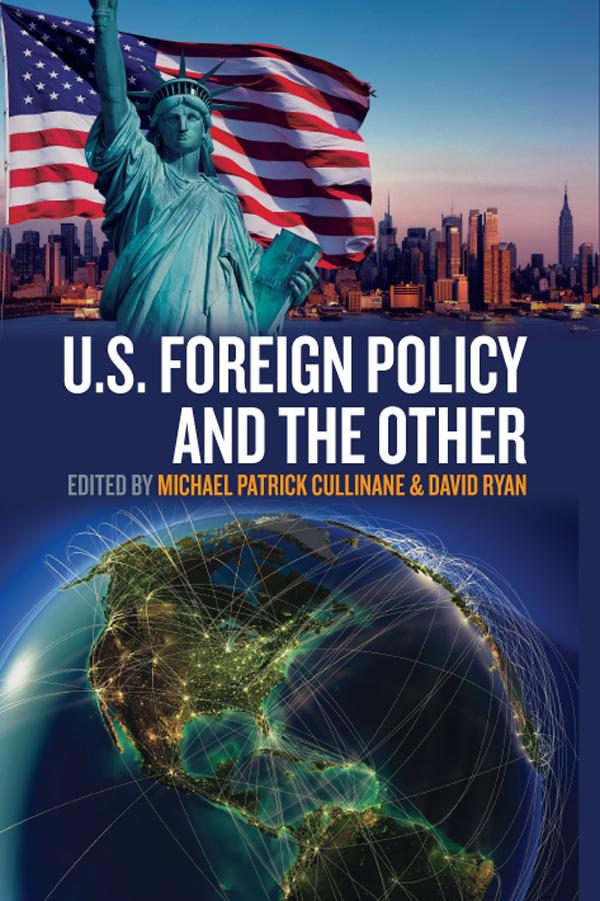
U.S. Foreign Policy and the Other John Quincy Adams warned Americans not to search abroad for monsters to destroy, yet such figures have frequently habituated the discourses of U.S. foreign policy. This collection of essays focuses on counter-identities in American consciousness to explain how foreign policies and the discourse surrounding them develop. Whether it is the seemingly ubiquitous evil of Hitler during World War II or the more complicated perceptions of communism throughout the Cold War, these essays illuminate the cultural contexts that constructed rival identities. The authors challenge our understanding of “others,†looking at early applications of the concept in the eighteenth century to recent twenty-first century conflicts, establishing how this phenomenon is central to decision making through centuries of conflict. POLITICAL SCIENCE,International Relations,General
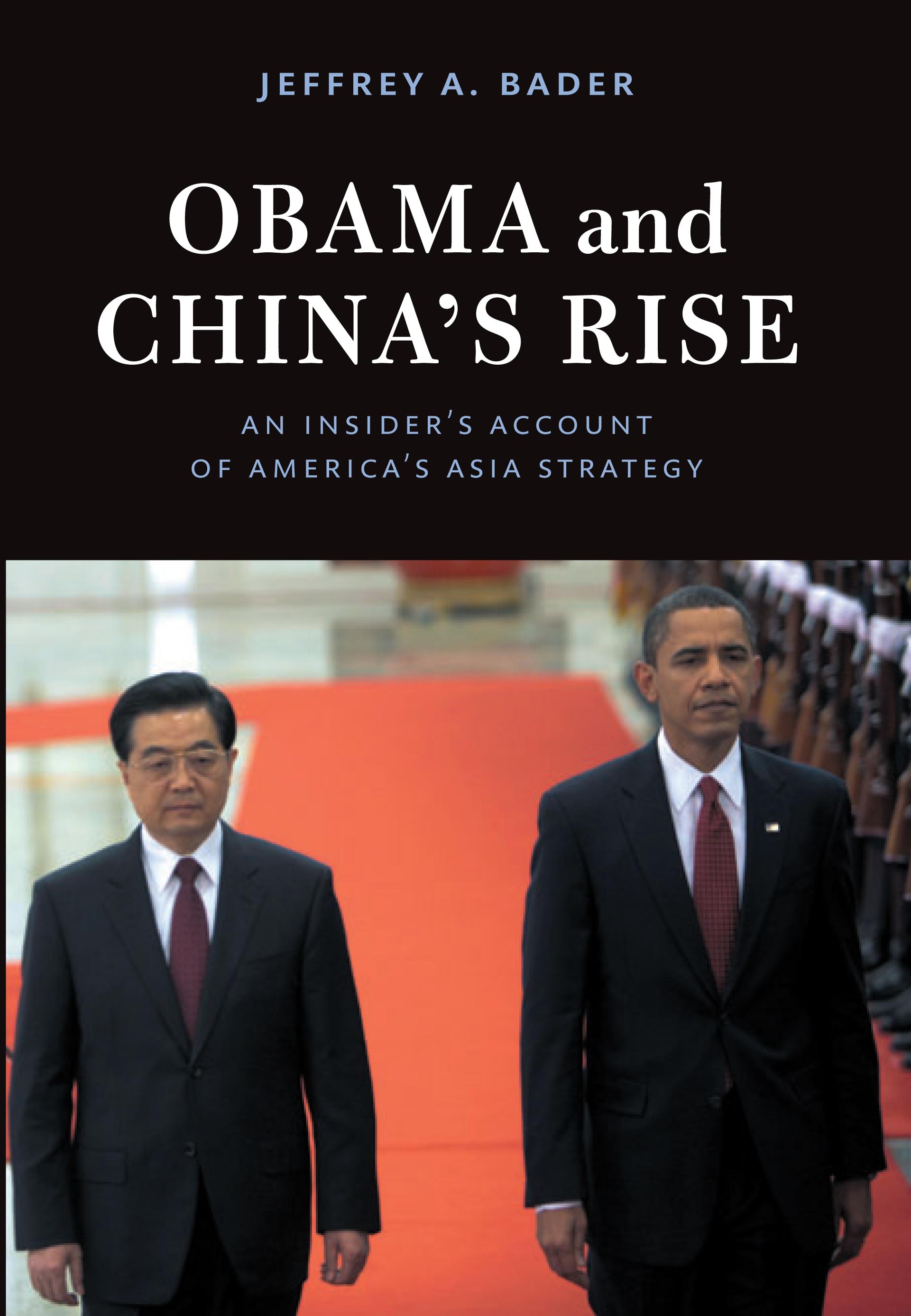
Obama and China's Rise "Future presidents will need to find the right balance in China policy, so as to maintain America's strength and watchfulness but not fall into the classic security dilemma, wherein each side believes that growing capabilities reflect hostile intent and responds by producing that reality. I believe that President Obama struck that balance." From Obama and China's Rise In 2005, veteran diplomat and Asia analyst Jeffrey Bader met for the first time with the then-junior U.S. senator from Illinois. When Barack Obama entered the White House a few years later, Bader was named the senior director for East Asian affairs on the National Security Council, becoming one of a handful of advisers responsible for formulating and implementing the administration's policy regarding that key region. For obvious reasonsa booming economy, expanding military power, and increasing influence over the regionthe looming impact of a rising China dominated their efforts. Obama's original intent was to extend U.S. influence and presence in East Asia, which he felt had been neglected by a Bush administration fixated on the Middle East, particularly Iraq, and the war on terror. China's rise, particularly its military buildup, was heightening anxiety among its neighbors, including key U.S. allies Japan and South Korea. Bader explains the administration's efforts to develop stable relations with China while improving relationships with key partners worried about Beijing's new assertiveness. In Obama and China's Rise, Bader reveals what he did, discusses what he saw, and interprets what it meantfirst during the Obama campaign, and then for the administration. The result is an illuminating backstage view of the formulation and execution of American foreign policy as well as a candid assessment of both. Bader combines insightful and authoritative foreign policy analysis with a revealing and humanizing narrative of his own personal journey. POLITICAL SCIENCE,International Relations,General
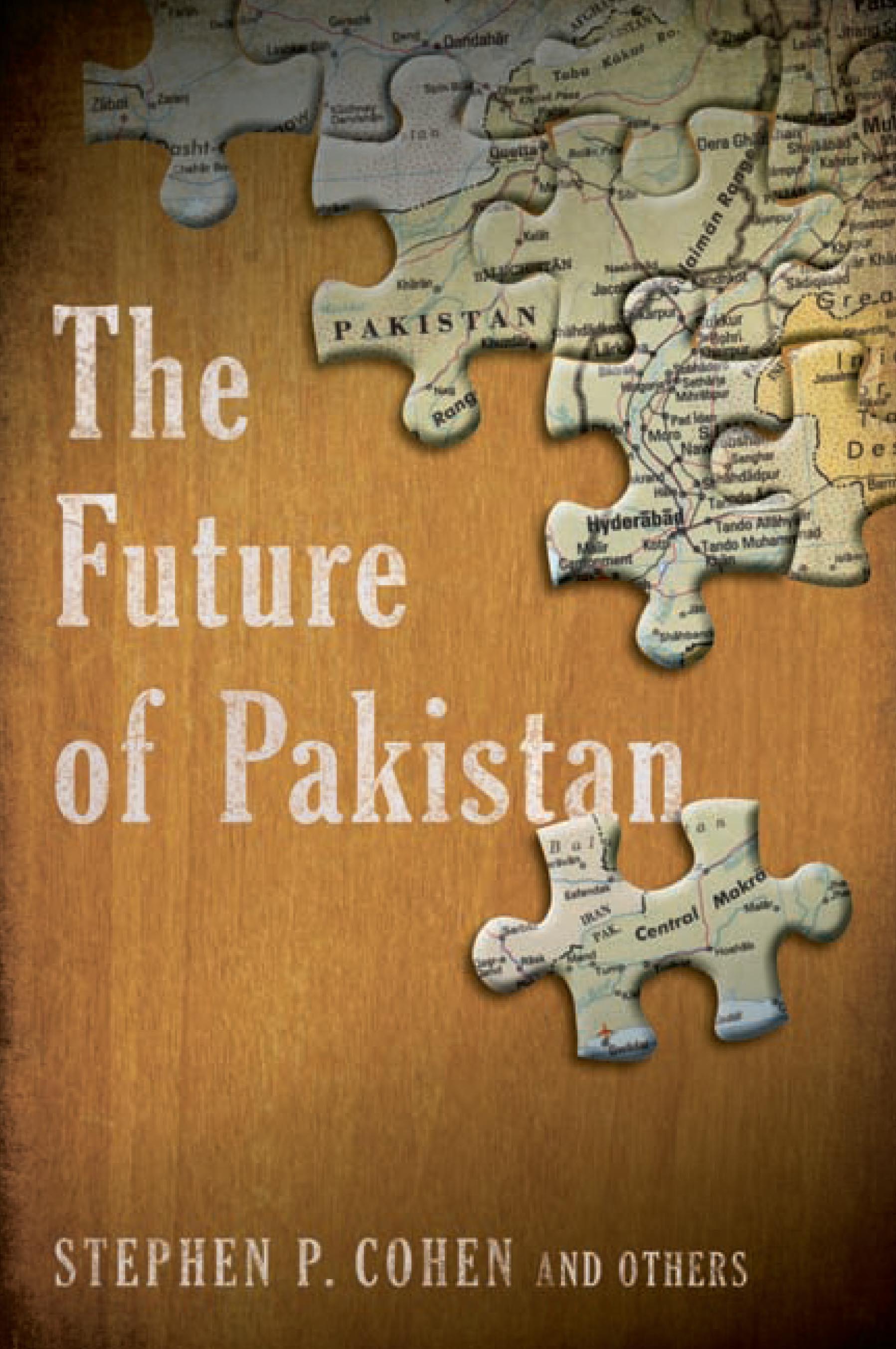
The Future of Pakistan With each passing day, Pakistan becomes an even more crucial player in world affairs. Home of the world's second-largest Muslim population, epicenter of the global jihad, location of perhaps the planet's most dangerous borderlands, and armed with nuclear weapons, this South Asian nation will go a long way toward determining what the world looks like ten years from now. The Future of Pakistan presents and evaluates several scenarios for how the country will develop, evolve, and act in the near future, as well as the geopolitical implications of each. Led by renowned South Asia expert Stephen P. Cohen, a team of authoritative contributors looks at several pieces of the Pakistan puzzle. The book begins with Cohen's broad yet detailed overview of Pakistan, placing it within the context of current-day geopolitics and international economics. Cohen's piece is then followed by a number of shorter, more tightly focused essays addressing more specific issues of concern. Cohen's fellow contributors hail from America, Europe, India, and Pakistan itself, giving the book a uniquely international and comparative perspective. They address critical factors such as the role and impact of radical groups and militants, developments in specific key regions such as Punjab and the rugged frontier with Afghanistan, and the influence ofand interactions withIndia, Pakistan's archrival since birth. The book also breaks down relations with other international powers such as China and the United States. The all-important military and internal security apparatus come under scrutiny, as do rapidly morphing social and gender issues. Political and party developments are examined along with the often amorphous division of power between Islamabad and the nation's regions and local powers. Uncertainty about Pakistan's trajectory persists. The Future of Pakistan helps us understand the current circumstances, the relevant actors and their motivation, the crit POLITICAL SCIENCE,International Relations,General

What We Won In February 1989, the CIA's chief in Islamabad famously cabled headquarters a simple message: "We Won." It was an understated coda to the most successful covert intelligence operation in American history. In What We Won, CIA and National Security Council veteran Bruce Riedel tells the story of America's secret war in Afghanistan and the defeat of the Soviet 40th Red Army in the war that proved to be the final battle of the cold war. He seeks to answer one simple questionwhy did this intelligence operation succeed so brilliantly? Riedel has the vantage point few others can offer: He was ensconced in the CIA's Operations Center when the Soviet Union invaded Afghanistan on Christmas Eve 1979. The invasion took the intelligence community by surprise. But the response, initiated by Jimmy Carter and accelerated by Ronald Reagan, was a masterful intelligence enterprise. Many books have been written about intelligence failuresfrom Pearl Harbor to 9/11. Much less has been written about how and why intelligence operations succeed. The answer is complex. It involves both the weaknesses and mistakes of America's enemies, as well as good judgment and strengths of the United States. Riedel introduces and explores the complex personalities pitted in the warthe Afghan communists, the Russians, the Afghan mujahedin, the Saudis, and the Pakistanis. And then there are the Americansin this war, no Americans fought on the battlefield. The CIA did not send officers into Afghanistan to fight or even to train. In 1989, victory for the American side of the cold war seemed complete. Now we can see that a new era was also beginning in the Afghan war in the 1980s, the era of the global jihad. This book examines the lessons we can learn from this intelligence operation for the future and makes some observations on what came next in Afghanistanand what is likely yet to come. POLITICAL SCIENCE,International Relations,General

Can Russia Compete? In recent years the Russian government, concerned about sustaining its economic performance, has sought to promote more diversified and broader economic growth beyond the profitable natural-resource sector. Economic officials would like to see something closer to a "knowledge-based economy." One of the areas in clear need of upgrading is the manufacturing sector. This book quantifies and benchmarks the relative strengths of that sector, identifying opportunities to increase Russian productivity and competitiveness. Drawing on original survey data from Russian firms of all sizes, the authors formulate proposals that aim to enhance the innovative potential of Russian firms, upgrade the skills of their workforce, and develop a business-friendly climate of lower administrative costs and greater policy certainty. This book examines the underlying firm-level determinants of knowledge absorption, competitiveness, and productivity, with an eye to improving workers' skill levels and improving the investment climate, which should in turn enhance the innovation needed to keep up in a globalized economy. The original research and analysis of Desai, Goldberg, and their colleagues will be of use to anyone interested in the problems of building manufacturing competitiveness, especially in Russia and the post-Soviet transition economies. It will also be of interest to organizations planning to do business with Russia or to invest in it. POLITICAL SCIENCE,International Relations,General

National Interests in International Society How do states know what they want? Asking how interests are defined and how changes in them are accommodated, Martha Finnemore shows the fruitfulness of a constructivist approach to international politics. She draws on insights from sociological... POLITICAL SCIENCE,International Relations,General
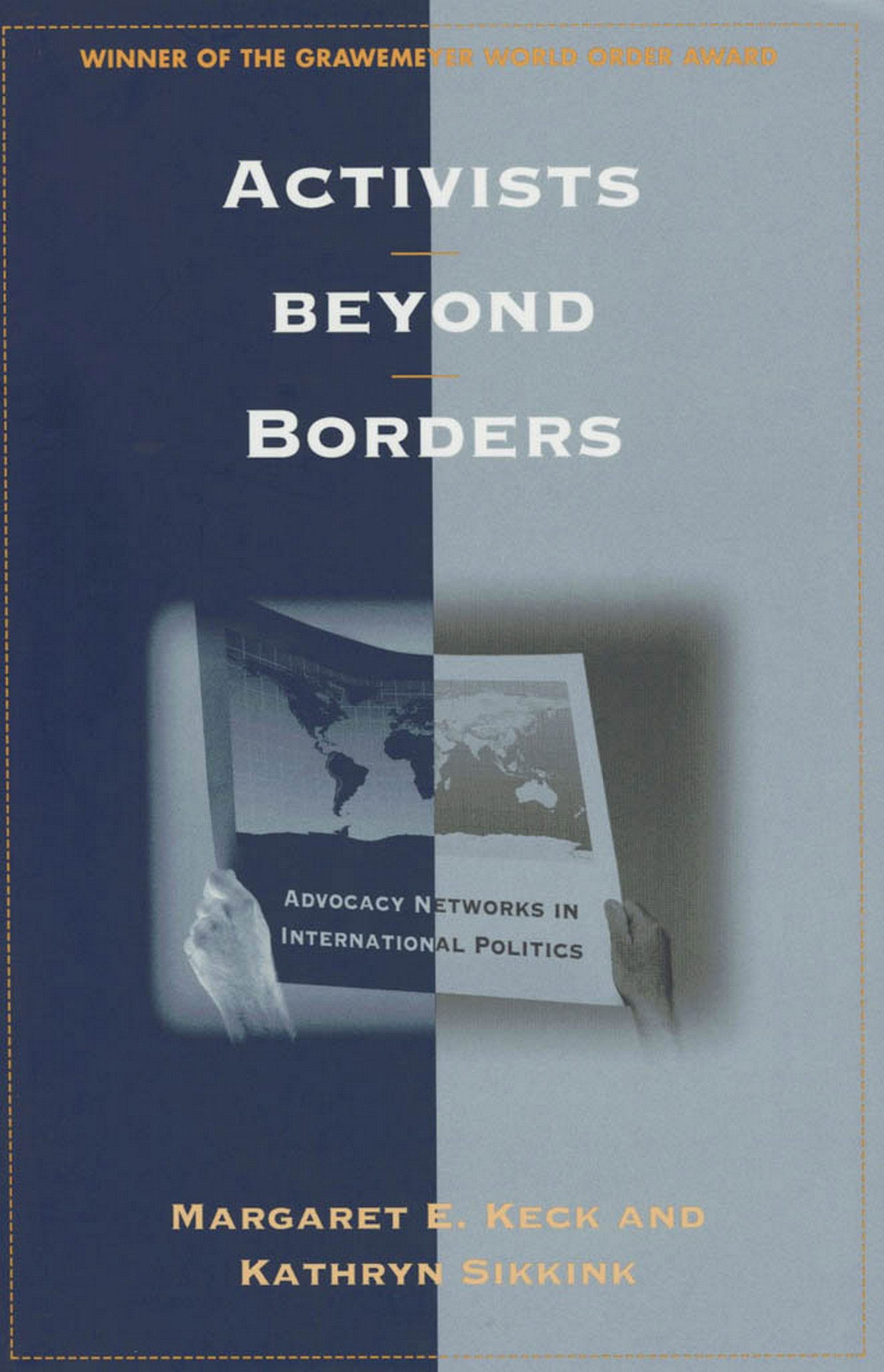
Activists beyond Borders In Activists beyond Borders, Margaret E. Keck and Kathryn Sikkink examine a type of pressure group that has been largely ignored by political analysts: networks of activists that coalesce and operate across national frontiers. Their targets may be... POLITICAL SCIENCE,International Relations,General

In Uncertain Times Insider accounts of how policymakers reacted to dramatic developments in recent history. POLITICAL SCIENCE,International Relations,General

White World Order, Black Power Politics In White World Order, Black Power Politics, Robert Vitalis recovers the arguments, texts, and institution building of an extraordinary group of professors at Howard University, including Alain Locke, Ralph Bunche, Rayford Logan, Eric Williams, and Merze Tate, who was the first black female professor of political science in the country. POLITICAL SCIENCE,International Relations,General

WikiLeaks Published to coincide with the forthcoming film, The Fifth Estate, starring Beneditct Cumberbatch, this tie-in edition contains two new chapters on Julian Assange and Bradley Manning, and a foreword by Alan Rusbridger. It was the biggest leak in history. WikiLeaks infuriated the world's greatest superpower, embarrassed the British royal family and helped cause a revolution in Africa. The man behind it was Julian Assange, one of the strangest figures ever to become a worldwide celebrity. Was he an internet messiah or a cyber-terrorist? Information freedom fighter or sex criminal? The debate echoed around the globe as US politicians called for his assassination. And Assange's actions continue to be felt, in the trial of Bradley Manning and the flight of Edward Snowden, the NSA whistleblower. Award-winning Guardian journalists David Leigh and Luke Harding were at the centre of a unique publishing drama that involved the release of some 250,000 secret diplomatic cables and classified files from the Afghan and Iraq wars. (At one point the platinum-haired hacker was hiding from the CIA in David Leigh's London house.) Now, together with the paper's investigative reporting team, Leigh and Harding reveal the startling inside story of the man and the leak, and bring the story dramatically up to date. POLITICAL SCIENCE,International Relations,General

The Washington Dissensus An insider's perspective on how international politics really works by the Brazilian Ambassador to the United States POLITICAL SCIENCE,International Relations,General
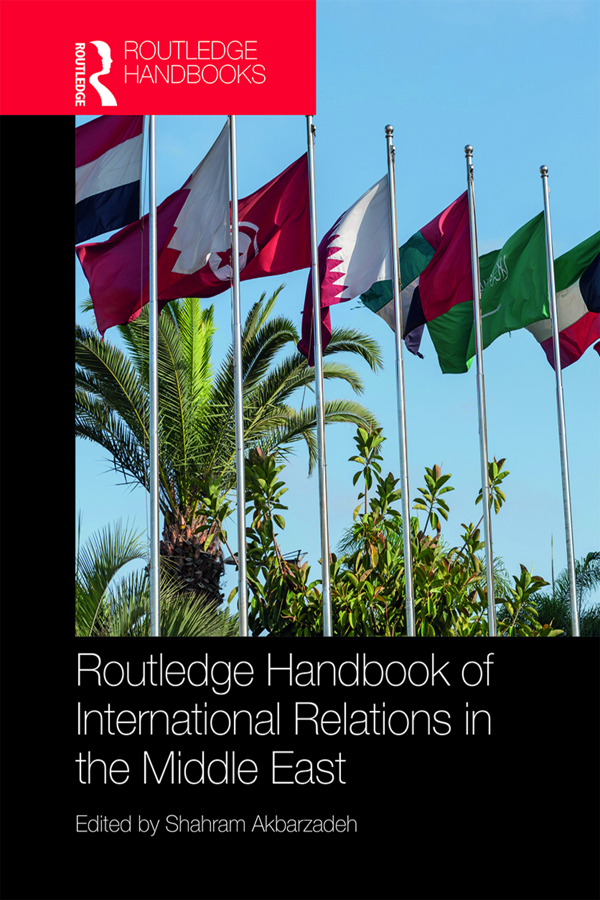
Routledge Handbook of International Relations in the Middle East This handbook examines the regional and international dynamics of the Middle East. It challenges the state society dichotomy to make sense of decision-making and behavior by ruling regimes. The 33 chapter authors include the world’s leading scholars of the Middle East and International Relations (IR) in order to make sense of the region. This synthesis of area studies expertise and IR theory provides a unique and rigorous account of the region’s current dynamics, which have reached a crisis point since the beginning of the Arab Spring. The Middle East has been characterized by volatility for more than a century. Although the region attracts significant scholarly interest, IR theory has rarely been used as a tool to understand events. The constructivist approach in IR highlights the significance of state identity, shaped by history and culture, in making sense of international relations. The authors of this volume consider how IR theory can elucidate the patterns and principles that shape the region, in order to provide a rigorous account of the contemporary challenges of the Middle East. The Routledge Handbook of International Relations in the Middle East provides comprehensive coverage of International Relations issues in the region. Thus, it offers key resources for researchers and students interested in International Relations and the Middle East. POLITICAL SCIENCE,International Relations,General
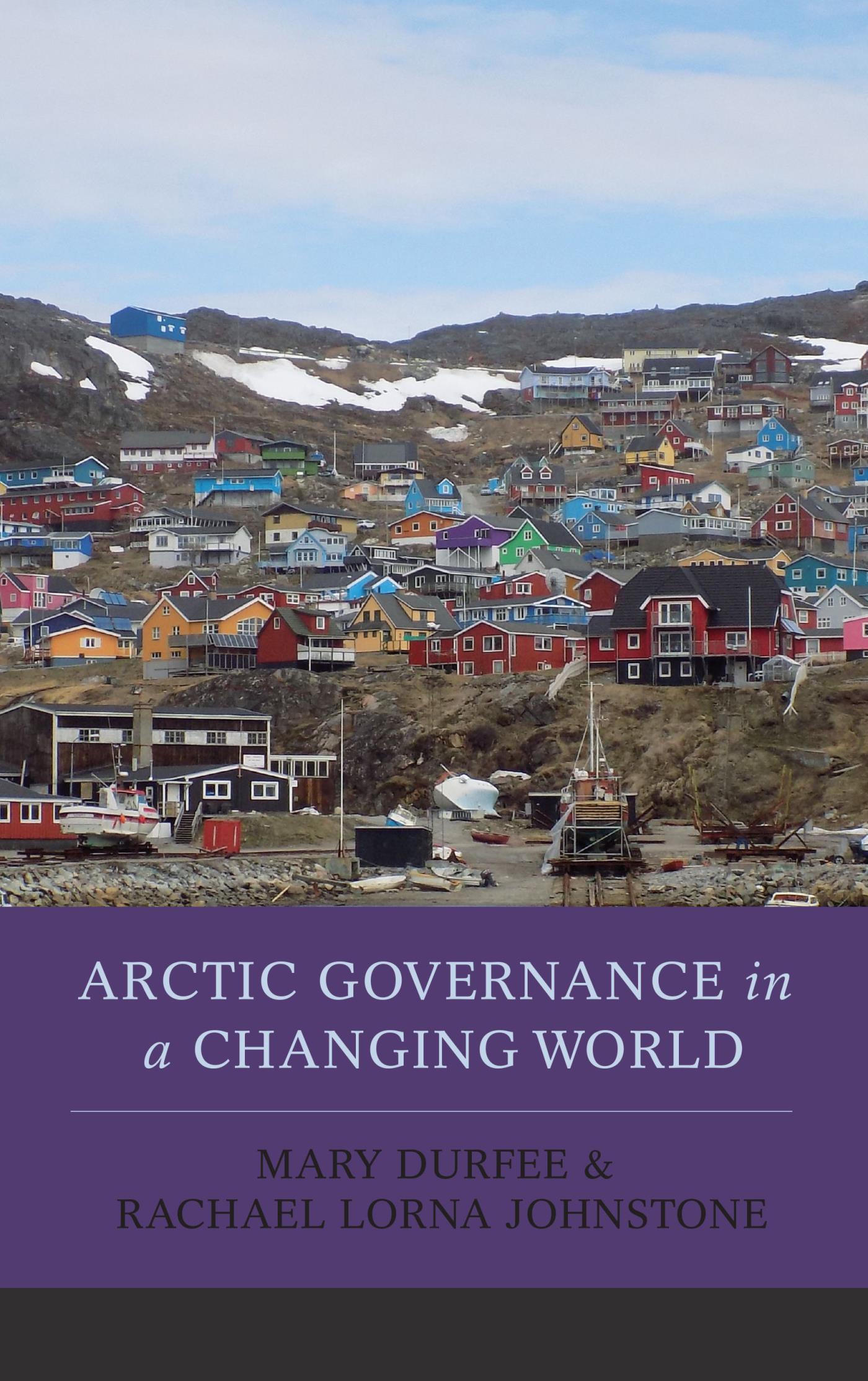
Arctic Governance in a Changing World This comprehensive text explains the relationship between the Arctic and the wider world through the lenses of international relations, international law, and political economy. It is an essential resource for any student or scholar seeking a clear and succinct account of a region of ever-growing international importance. POLITICAL SCIENCE,International Relations,General
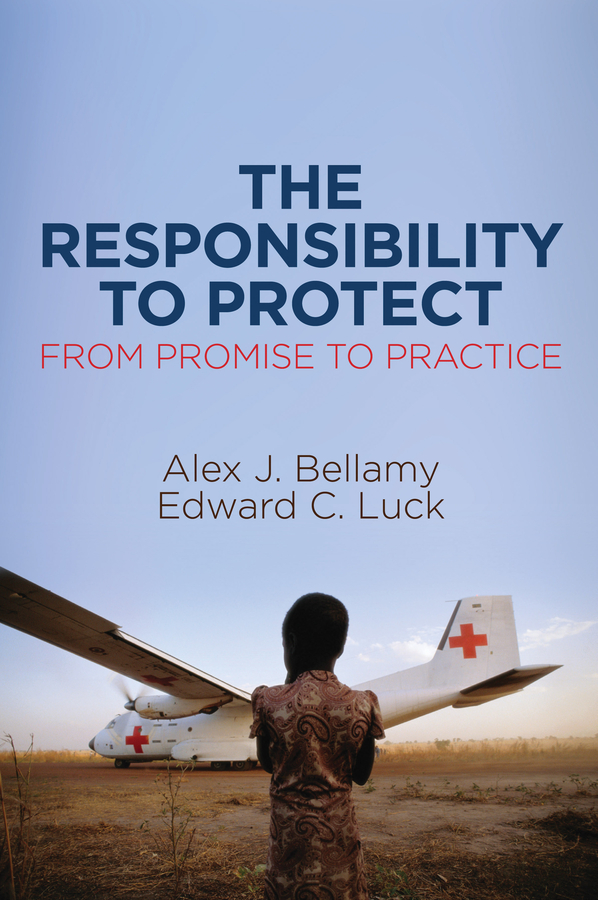
The Responsibility to Protect In 2005, the international community made a landmark commitment to prevent mass atrocities by unanimously adopting the UN’s “Responsibility to Protect†(R2P) principle. As often as not, however, R2P has failed to translate into decisive action. Why does this gap persist between the world’s normative pledges to R2P and its ability to make it a daily lived reality? In this new book, leading global authorities on humanitarian protection Alex Bellamy and Edward Luck offer a probing and in-depth response to this fundamental question, calling for a more comprehensive approach to the practice of R2P – one that moves beyond states and the UN to include the full range of actors that play a role in protecting vulnerable populations. Drawing on cases from the Middle East to sub-Saharan Africa and Southeast Asia, they examine the forces and conditions that produce atrocity crimes and the challenge of responding to them quickly and effectively. Ultimately, they advocate both for emergency policies to temporarily stop carnage and for policies leading to sustainable change within societies and governments. Only by introducing these additional elements to the R2P toolkit will the failures associated with humanitarian crises like Syria and Libya become a thing of the past. POLITICAL SCIENCE,International Relations,General

Antarrashtreey Rajneeti This multi-authored textbook helps to critically understand the major concepts, theories and issues of international politics in a constantly changing environment. Designed as a core textbook for undergraduate and postgraduate students, this book provides a roadmap to orient students to the main concepts, theories and issues in world politics today. Each chapter provides an analytical overview of the issues addressed, identifies the central actors and perspectives, and outlines past progress and future prospects. The highlight of the book is a critical overview of the major theories of international politics apart from a fairly detailed chapter on India’s foreign policy. This revised edition includes new chapters on the impacts of globalization, regionalism and global politics and perspectives from the global South. Debates and discourses on contemporary issues such as terrorism, human rights, development, security and the role and relevance of international organizations have been updated to suit recent curriculum requirements. Key Features • Critical overview of the major theories and issues of international politics • Updated data added with illustrations in every chapter • Each chapter aided by model questions for classroom discussion POLITICAL SCIENCE,International Relations,General

Security in Northern Europe NATO’s Northern members are increasingly concerned about Russia’s military activities. This Whitehall Paper contains perspectives from prominent authors across the region, showing how member states are responding, individually and collectively, to Moscow’s resurgence. Overall, it identifies the common but differentiated responsibility that member states have for security in the Alliance’s northern regions. POLITICAL SCIENCE,International Relations,General
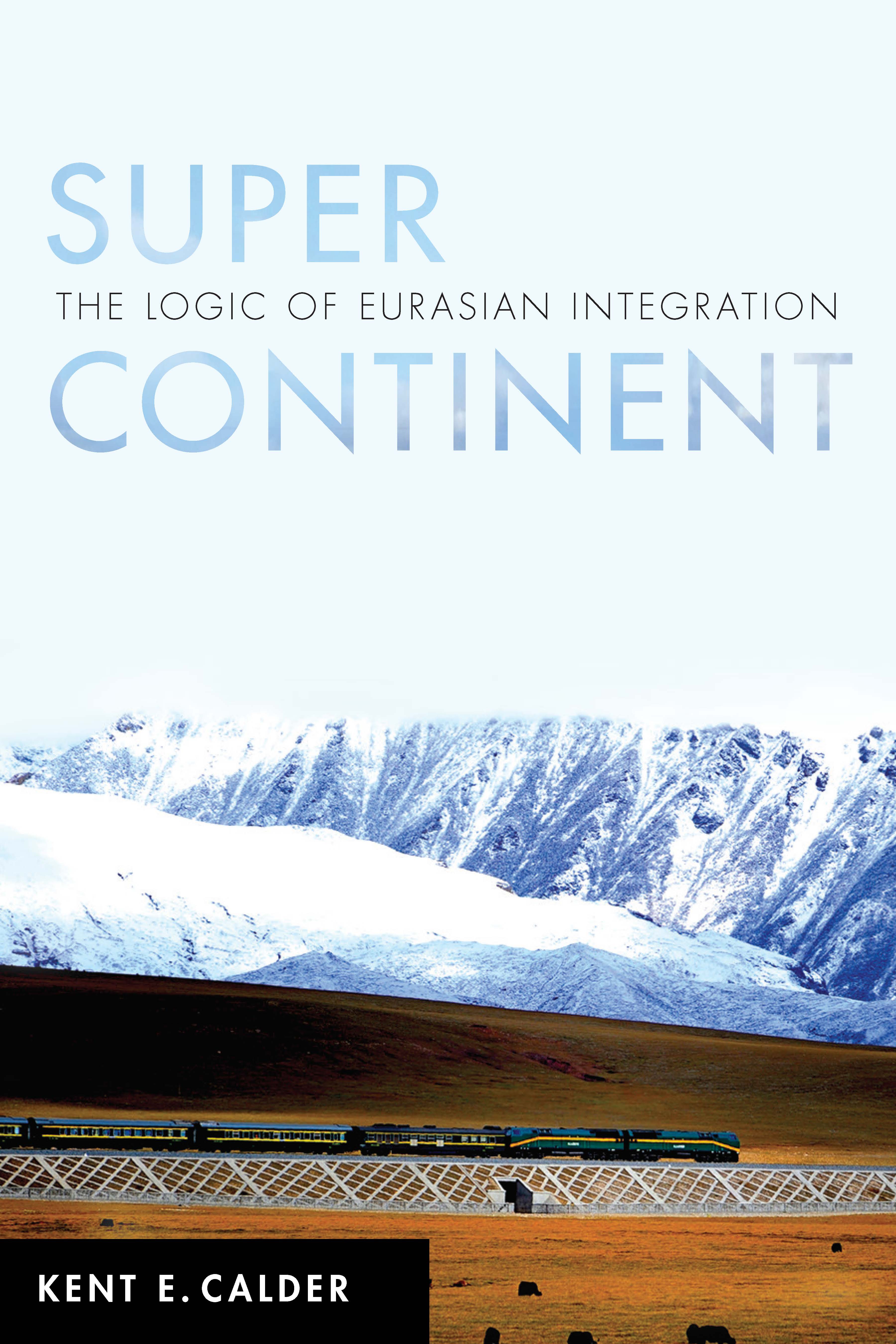
Super Continent A Eurasian transformation is underway, and it flows from China. With a geopolitically central location, the country's domestic and international policies are poised to change the face of global affairs. The Belt and Road Initiative has called attention to a deepening Eurasian continentalism that has, argues Kent Calder, much more significant implications than have yet been recognized. In Super Continent, Calder presents a theoretically guided and empirically grounded explanation for these changes. He shows that key inflection points, beginning with the Four Modernizations and the collapse of the Soviet Union; and culminating in China's response to the Global Financial Crisis and Crimea's annexation, are triggering tectonic shifts. Furthermore, understanding China's emerging regional and global roles involves comprehending two ongoing transformations—within China and across Eurasia as a whole—and that the two are profoundly interrelated. Calder underlines that the geo-economic logic that prevailed across Eurasia before Columbus, and that made the Silk Road a central thoroughfare of world affairs for close to two millennia, is reasserting itself once again. POLITICAL SCIENCE,International Relations,General

The International Politics of the Asia-Pacific This fully revised fourth edition of Michael Yahuda's successful textbook brings the subject up-to-date, introducing students to the international politics of the Asia-Pacific region since 1945. As well as assessing the post-cold War uncertainties that challenged balance and power with the region, the book also examines the first two decades of the new millennium, which includes no let up on the 'war on terror', new political administrations in all the key player-states and increased cooperative security between some nations, polarised by volatile relationships between others. Analyzing politics in terms of global, regional and local trends, this new edition features: Discussion and evaluation of the Trump Presidency and its implications for the Asia-Pacific region Analysis of Japan’s more assertive foreign policy Examination of the continued Rise of China under Xi Jinping in terms of politics, security, economic dominance and territorial conflicts in the region Ongoing debates concerning the 'war on terror' and how this shifts, forms and reforms relationships Explanation of how America’s war’s in the greater Middle East and the financial crash of 2008 undermined the American led international order. This new fourth edition will continue to be a core text for students of Asian politics, international relations and Cold War history. POLITICAL SCIENCE,International Relations,General
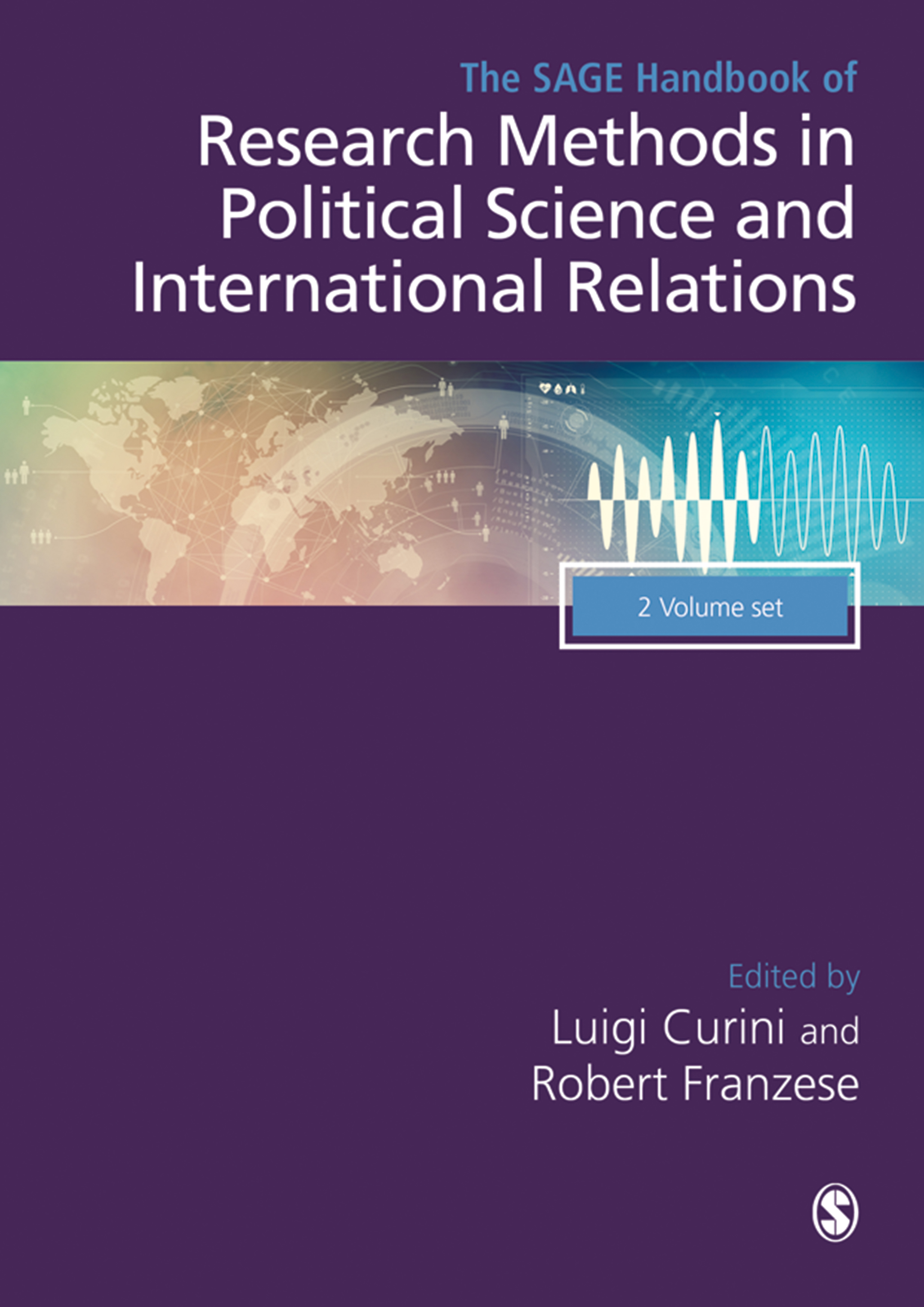
The SAGE Handbook of Research Methods in Political Science and International Relations The SAGE Handbook of Research Methods in Political Science and International Relations offers a comprehensive overview of the field and its research processes through the empirical and research scholarship of leading international authors. POLITICAL SCIENCE,International Relations,General
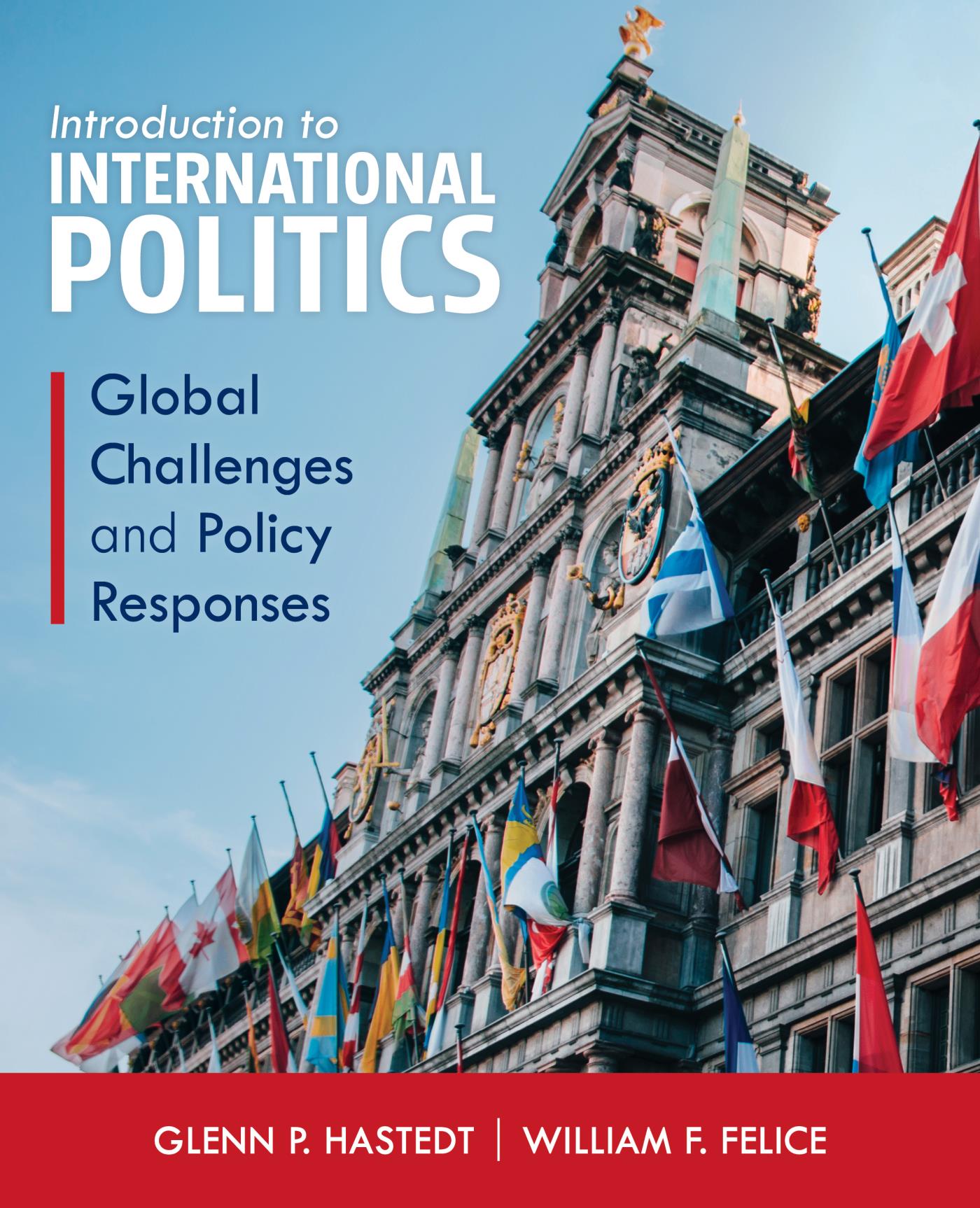
Introduction to International Politics This is a first edition core text for freshman/sophomore-level courses on International Relations—the second largest course market in political science. This book makes systematic linkages between theory and policy that do not ignore or slight the conceptual discussion of international relations or simply chase newspaper headlines. POLITICAL SCIENCE,International Relations,General
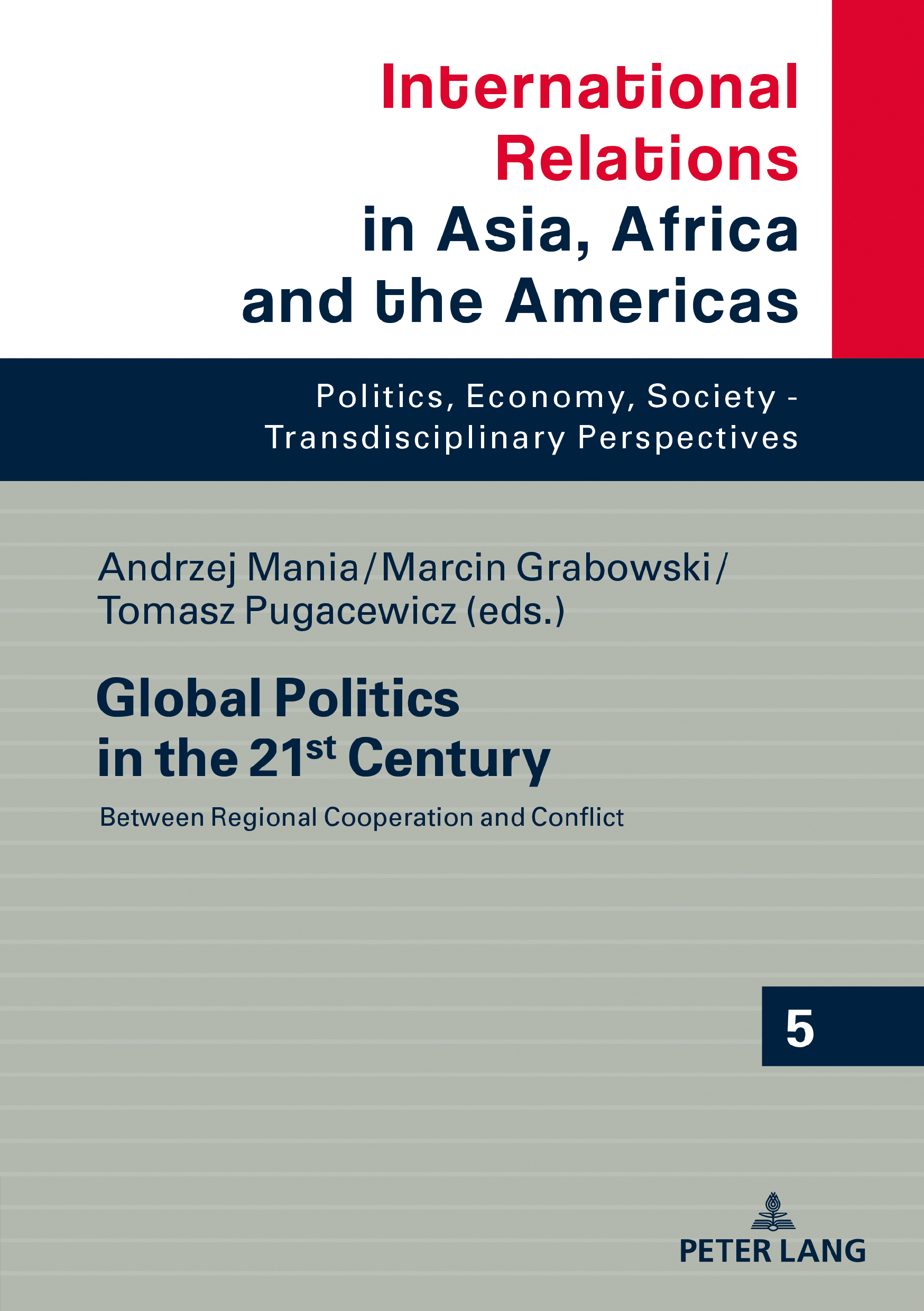
Global Politics in the 21st Century This book focuses on the problem of regionalism, the crucial phenomenon in international relations at early 21st century (both in terms of integration and conflict). The book analyzes theories of regional integration and regionalism and discusses challenges to regionalism in Asia, Africa and the European region. POLITICAL SCIENCE,International Relations,General

Foreign Policy Analysis Ideal for courses on foreign policy analysis and international relations theory, the third edition offers advanced undergraduates and beginning graduate students a cogently written overview of this broad field of study. Filled with illuminating examples, Hudson and Day consider theory and research at multiple levels of analysis. POLITICAL SCIENCE,International Relations,General
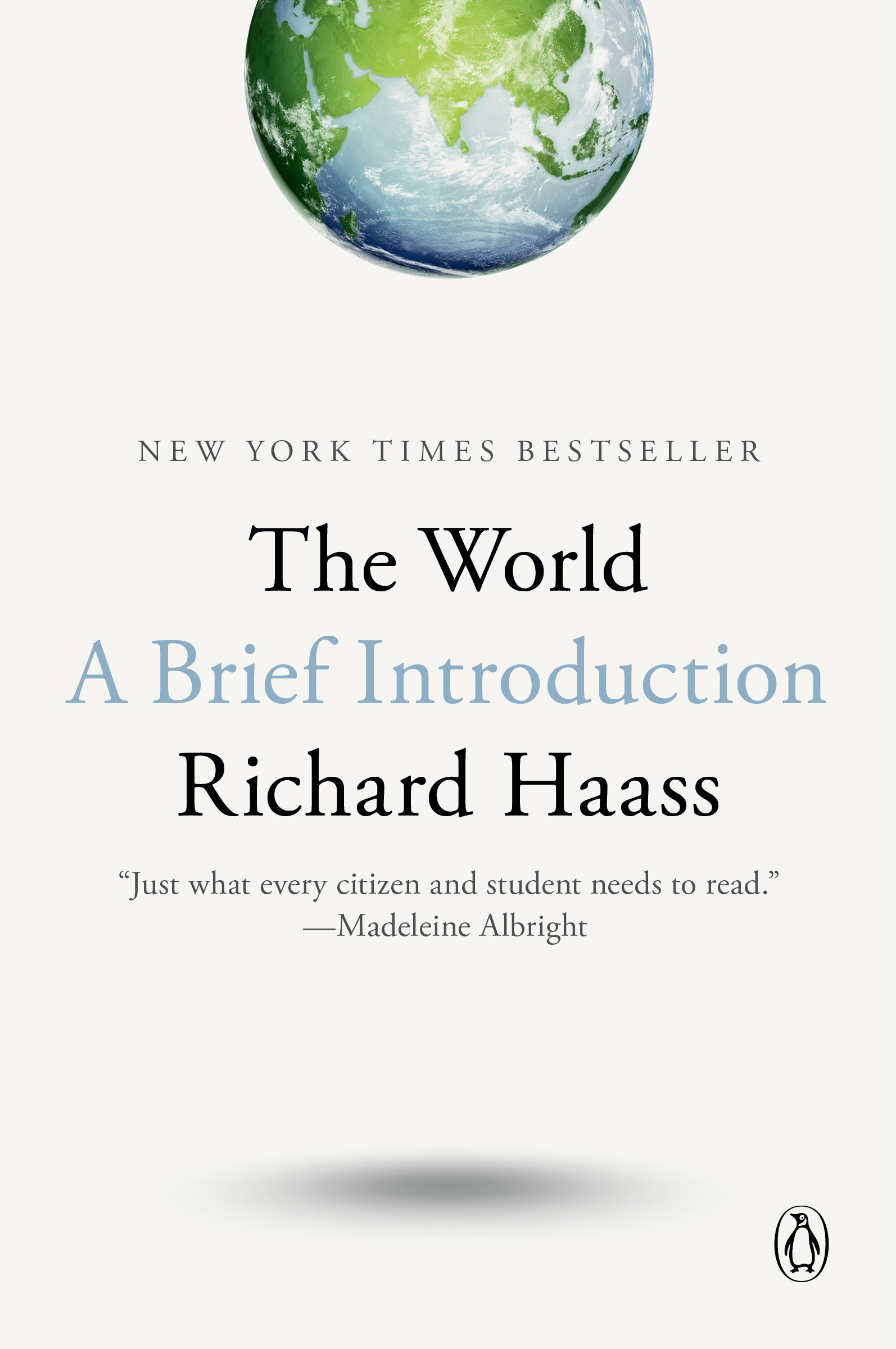
The World New York Times Bestseller An invaluable primer from Richard Haass, president of the Council on Foreign Relations, that will help anyone, expert and non-expert alike, navigate a time in which many of our biggest challenges come from the world beyond our borders. Like it or not, we live in a global era, in which what happens thousands of miles away has the ability to affect our lives. This time, it is a Coronavirus known as Covid-19, which originated in a Chinese city many had never heard of but has spread to the corners of the earth. Next time it could well be another infectious disease from somewhere else. Twenty years ago it was a group of terrorists trained in Afghanistan and armed with box-cutters who commandeered four airplanes and flew them into buildings (and in one case a field) and claimed nearly three thousand lives. Next time it could be terrorists who use a truck bomb or gain access to a weapon of mass destruction. In 2016 hackers in a nondescript office building in Russia traveled virtually in cyberspace to manipulate America's elections. Now they have burrowed into our political life. In recent years, severe hurricanes and large fires linked to climate change have ravaged parts of the earth; in the future we can anticipate even more serious natural disasters. In 2008, it was a global financial crisis caused by mortgage-backed securities in America, but one day it could well be a financial contagion originating in Europe, Asia, or Africa. This is the new normal of the 21st century. The World is designed to provide readers of any age and experience with the essential background and building blocks they need to make sense of this complicated and interconnected world. It will empower them to manage the flood of daily news. Readers will become more informed, discerning citizens, better able to arrive at sound, independent judgments. While it is impossible to predict what the next crisis will be or where it will originate, those who read The World will have what they need to understand its basics and the principal choices for how to respond. In short, this book will make readers more globally literate and put them in a position to make sense of this era. Global literacy--knowing how the world works--is a must, as what goes on outside a country matters enormously to what happens inside. Although the United States is bordered by two oceans, those oceans are not moats. And the so-called Vegas rule--what happens there stays there--does not apply in today's world to anyone anywhere. U.S. foreign policy is uniquely American, but the world Americans seek to shape is not. Globalization can be both good and bad, but it is not something that individuals or countries can opt out of. Even if we want to ignore the world, it will not ignore us. The choice we face is how to respond. We are connected to this world in all sorts of ways. We need to better understand it, both its promise and its threats, in order to make informed choices, be it as students, citizens, voters, parents, employees, or investors. To help readers do just that, The World focuses on essential history, what makes each region of the world tick, the many challenges globalization presents, and the most influential countries, events, and ideas. Explaining complex ideas with wisdom and clarity, Richard Haass's The World is an evergreen book that will remain relevant and useful as history continues to unfold. POLITICAL SCIENCE,International Relations,General

China Rx Millions of Americans are taking prescription drugs made in China and don't know it--and pharmaceutical companies are not eager to tell them. This is a disturbing, well-researched wake-up call for improving the current system of drug supply and manufacturing.Several decades ago, penicillin, vitamin C, and many other prescription and over-the-counter products were manufactured in the United States. But with the rise of globalization, antibiotics, antidepressants, birth control pills, blood pressure medicines, cancer drugs, among many others are made in China and sold in the United States. China's biggest impact on the US drug supply is making essential ingredients for thousands of medicines found in American homes and used in hospital intensive care units and operating rooms. The authors convincingly argue that there are at least two major problems with this scenario. First, it is inherently risky for the United States to become dependent on any one country as a source for vital medicines, especially given the uncertainties of geopolitics. For example, if an altercation in the South China Sea causes military personnel to be wounded, doctors may rely upon medicines with essential ingredients made by the adversary. Second, lapses in safety standards and quality control in Chinese manufacturing are a risk. Citing the concerns of FDA officials and insiders within the pharmaceutical industry, the authors document incidents of illness and death caused by contaminated medications that prompted reform. This probing book examines the implications of our reliance on China on the quality and availability of vital medicines. POLITICAL SCIENCE,International Relations,General

Between Peril and Promise In this concise introduction to international law, students gain a clear appreciation for how politics shapes the development of international law, and how international law shapes political relations between states. Throughout the book, Rochester takes this complex subject and makes it accessible with his vibrant, easy-to-read prose. POLITICAL SCIENCE,International Relations,General
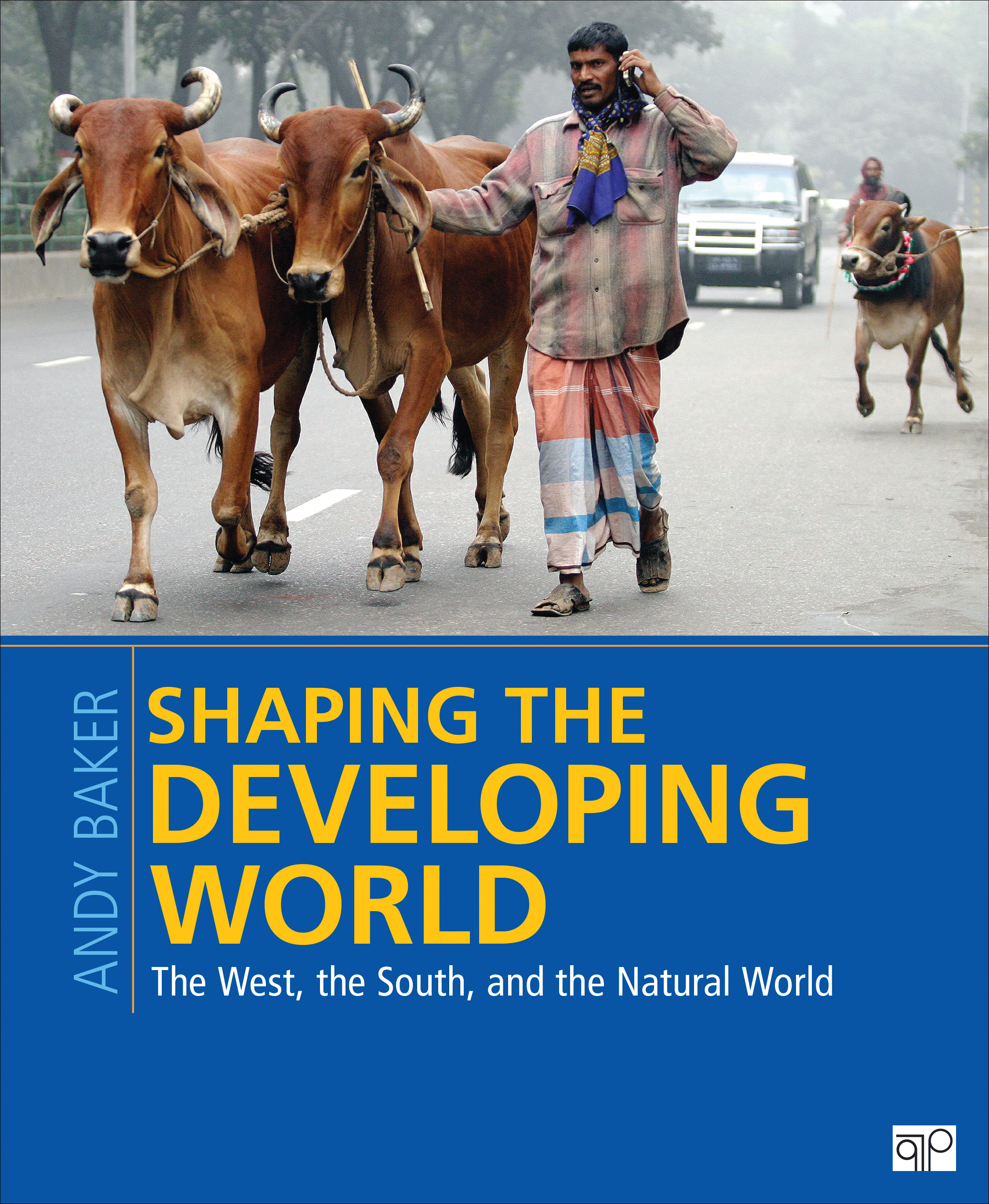
Shaping the Developing World Why are some countries rich and others poor? Shaping the Developing World: The West, the South, and the Natural World , by Andy Baker, attempts to answer this thorny question using a threefold framework to categorize and analyze the factors that cause underdevelopment—from the consequences of colonialism, deficient domestic institutions, and gender inequality to the effects of globalization, geography, and environmental degradation. Country case studies at the end of chapters offer an ideal testing ground for the threefold framework, as they apply empirical data to the various explanations. Critical thinking questions then encourage students to weigh the different theoretical arguments. A series of well-designed features develop students’ understanding of indicators of development concepts and highlight various kinds of aid organizations and opportunities for development work in the field. Shaping the Developing World presents high-quality academic analysis in a format that is both engaging and informative. POLITICAL SCIENCE,International Relations,General
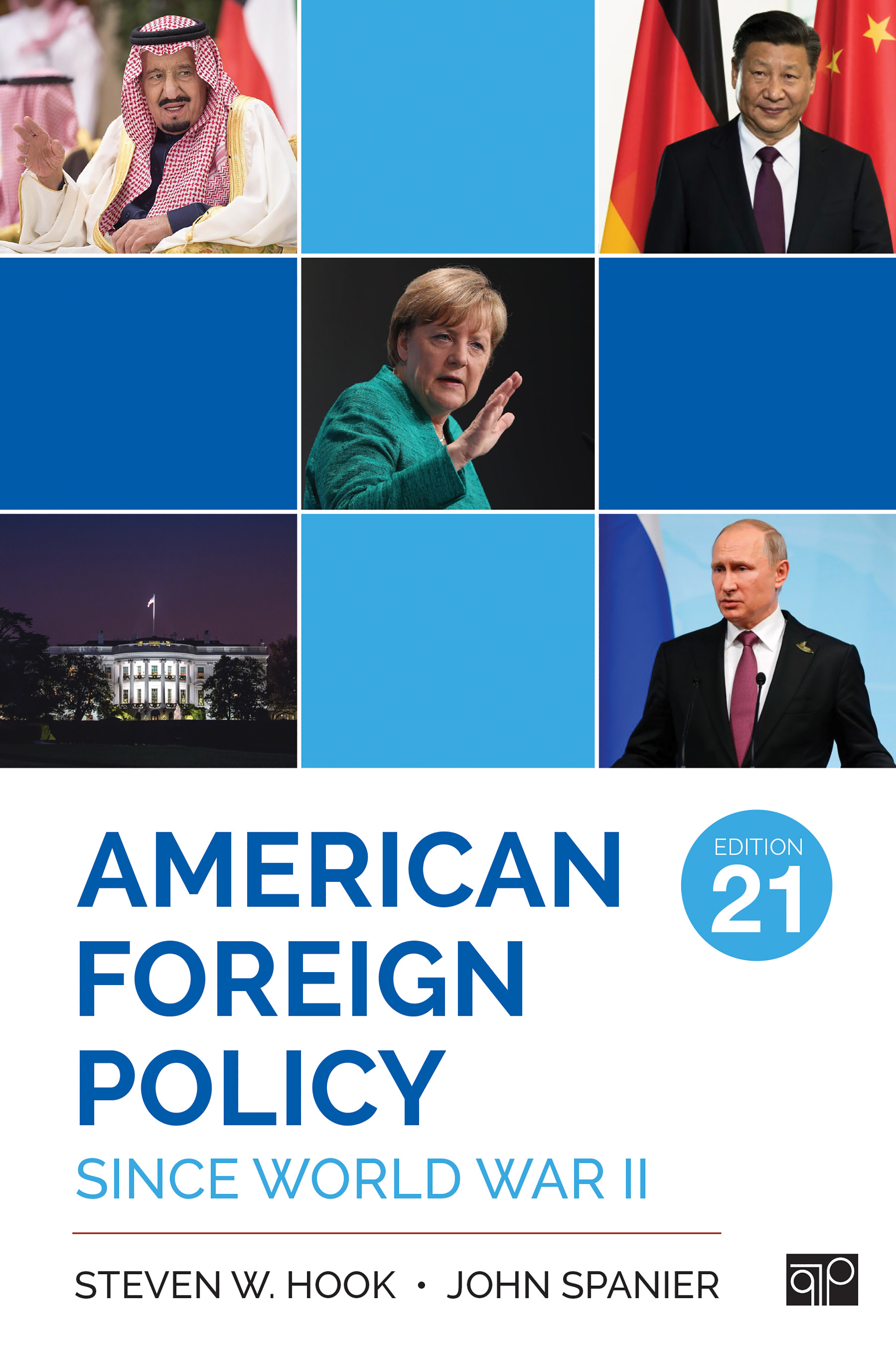
American Foreign Policy Since World War II The Gold Standard for Textbooks on American Foreign Policy American Foreign Policy Since World War II provides you with an understanding of America’s current challenges by exploring its historical experience as the world’s predominant power since World War II. Through this process of historical reflection and insight, you become better equipped to place the current problems of the nation’s foreign policy agenda into modern policy context. With each new edition, authors Steven W. Hook and John Spanier find that new developments in foreign policy conform to their overarching theme—there is an American “style†of foreign policy imbued with a distinct sense of national exceptionalism. This Twenty-First Edition continues to explore America’s unique national style with chapters that address the aftershocks of the Arab Spring and the revival of power politics. Additionally, an entirely new chapter devoted to the current administration discusses the implications of a changing American policy under the Trump presidency. POLITICAL SCIENCE,International Relations,General
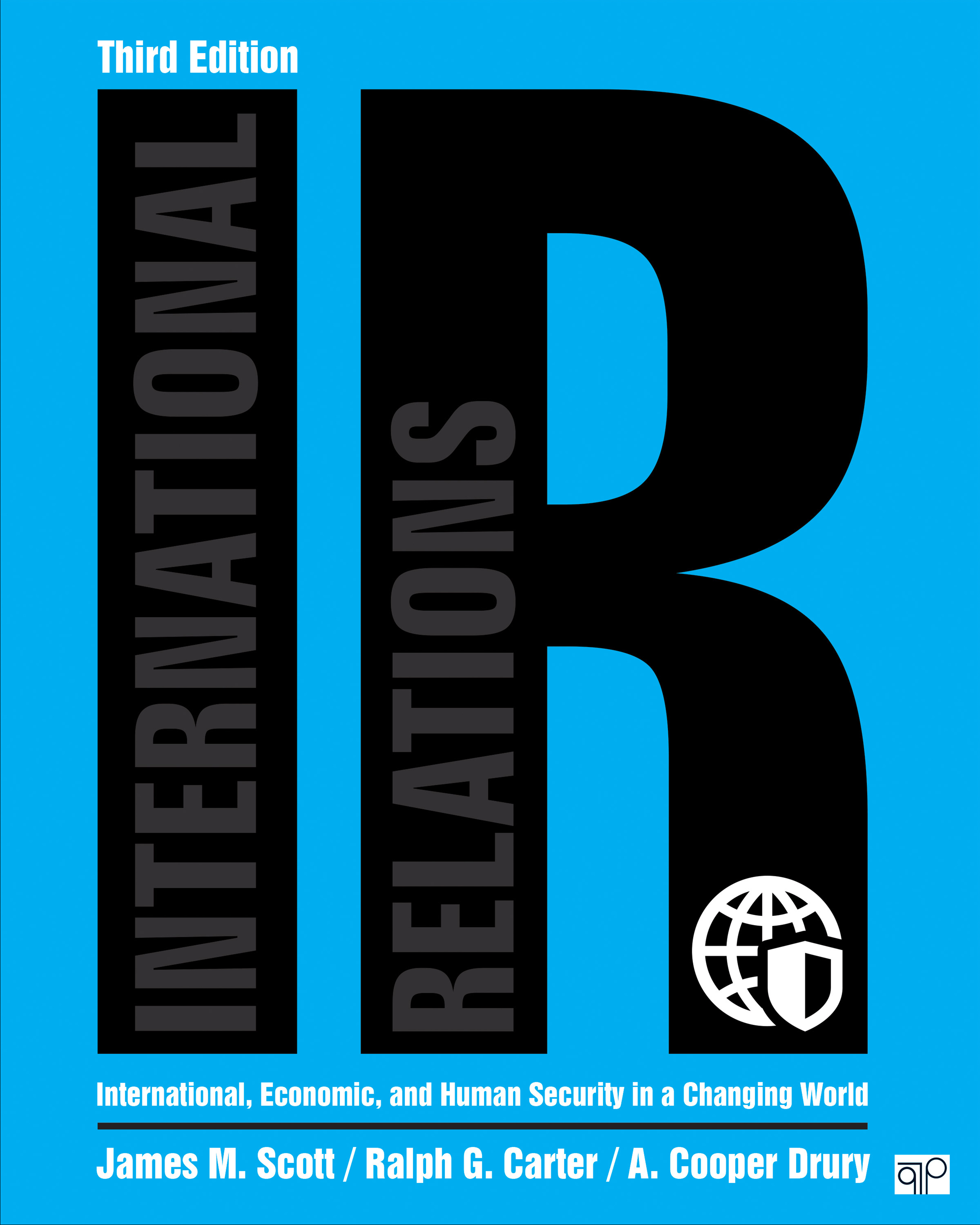
IR Now publishing with CQ Press, the Third Edition of IR: International, Economic, and Human Security in a Changing World explores the most current issues affecting the global community by analyzing how global actors seek international, economic, and human security. Award-winning scholars and authors James M. Scott, Ralph G. Carter, and A. Cooper Drury combine thought-provoking examples with practical learning tools to give you context and help you develop an understanding of not just what happens, but why and how it happens. Assuming no prior knowledge about international relations, the text provides you with a framework to understand what conditions behavior in the international arena—the challenges of anarchy, diversity, and complexity permeate the multitude of events that comprise of our world today. You will be able to make sense of the complicated events and interactions of world politics and come away with a broader view of the world’s geographical and political landscapes. New to the Third Edition: New discussions of key international trends and developments such as the shifts in power and leadership, the nature of and challenges to international order, the backlash against globalization and the rise of populism around the world. New and updated tables, charts, maps, and photographs illustrate important political events and players and bring concepts to life for today’s students. New and updated “Spotlight On†stories look at recent events happening in China, North Korea, Russia, and other countries to help students apply important concepts to real-world scenarios. New and updated “Theory in Action†examples feature contemporary theories about feminism, leadership, and more to demonstrate how ideas are directly translated into current policy and action. New and updated “The Revenge of Geography†feature with current issues such as “The Shrinking World,†turmoil in the African Great Lakes region, and more to demonstrate how a country’s borders and geography influences its relationships with neighboring countries. New and updated “Foreign Policy in Perspective†discussions explain how the dynamics of international relations have changed, putting into context the recent behavior and motivations of Russia’s interactions with its neighbors, Brexit, sanctions on North Korea, and more. POLITICAL SCIENCE,International Relations,General
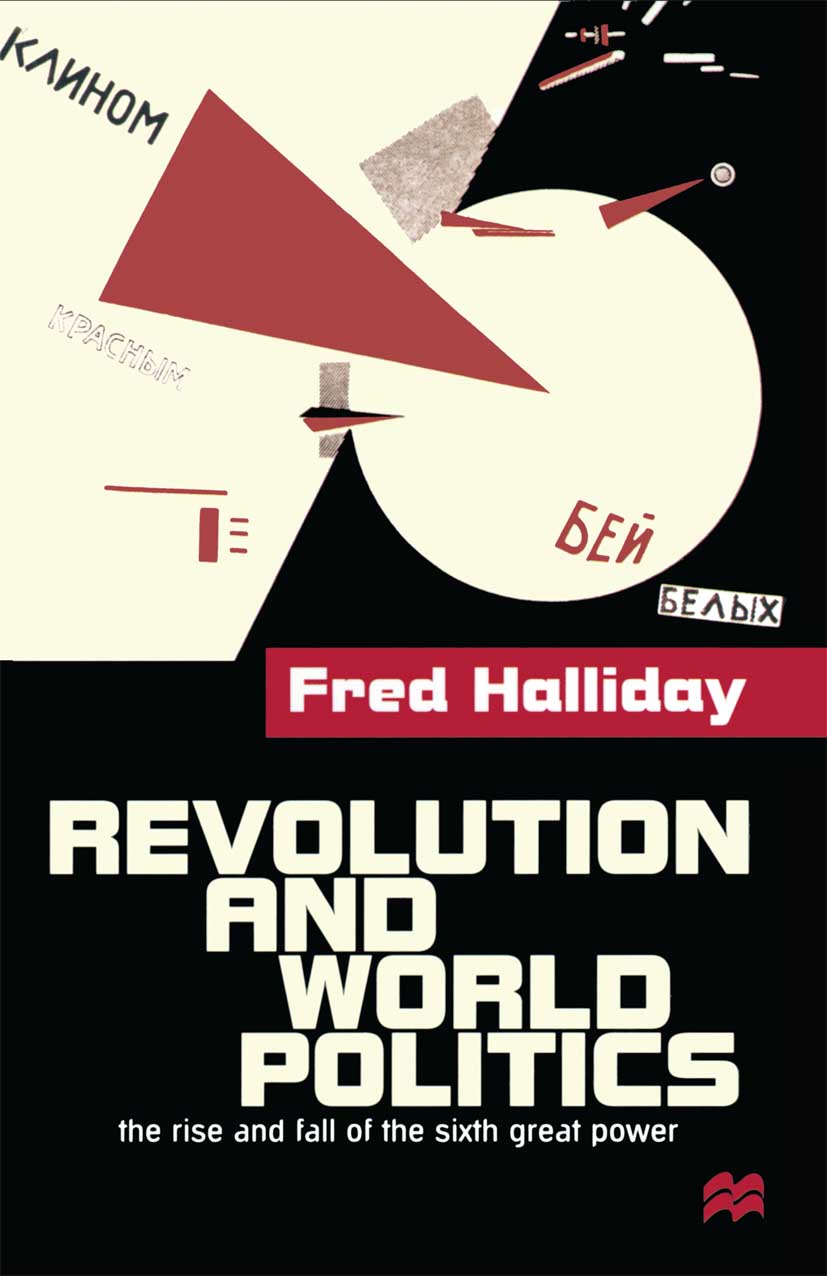
Revolution and World Politics The relation of revolutions to international relations is central to modern history. Revolutions have, as much as war or nationalism, shaped the development of world politics. Equally, revolutions have been, in cause, ideology and consequence, international events. By putting the international politics of revolution centre stage, Fred Halliday's book makes a major contribution to the understanding of both revolution and world politics. POLITICAL SCIENCE,International Relations,General

The Anarchical Society In this, his most systematic and fundamental work, Hedley Bull explores three key questions: what is the nature of order in world politics?; how is it maintained in the contemporary state system?; and what alternative paths to world order are feasible and desirable? He argues that the system of sovereign states is not in decline and is not an obstacle to world order but its essential foundation. This second edition includes a foreword by Stanley Hoffmann assessing the importance and relevance of Hedley Bull's text some two decades after its initial publication. POLITICAL SCIENCE,International Relations,General
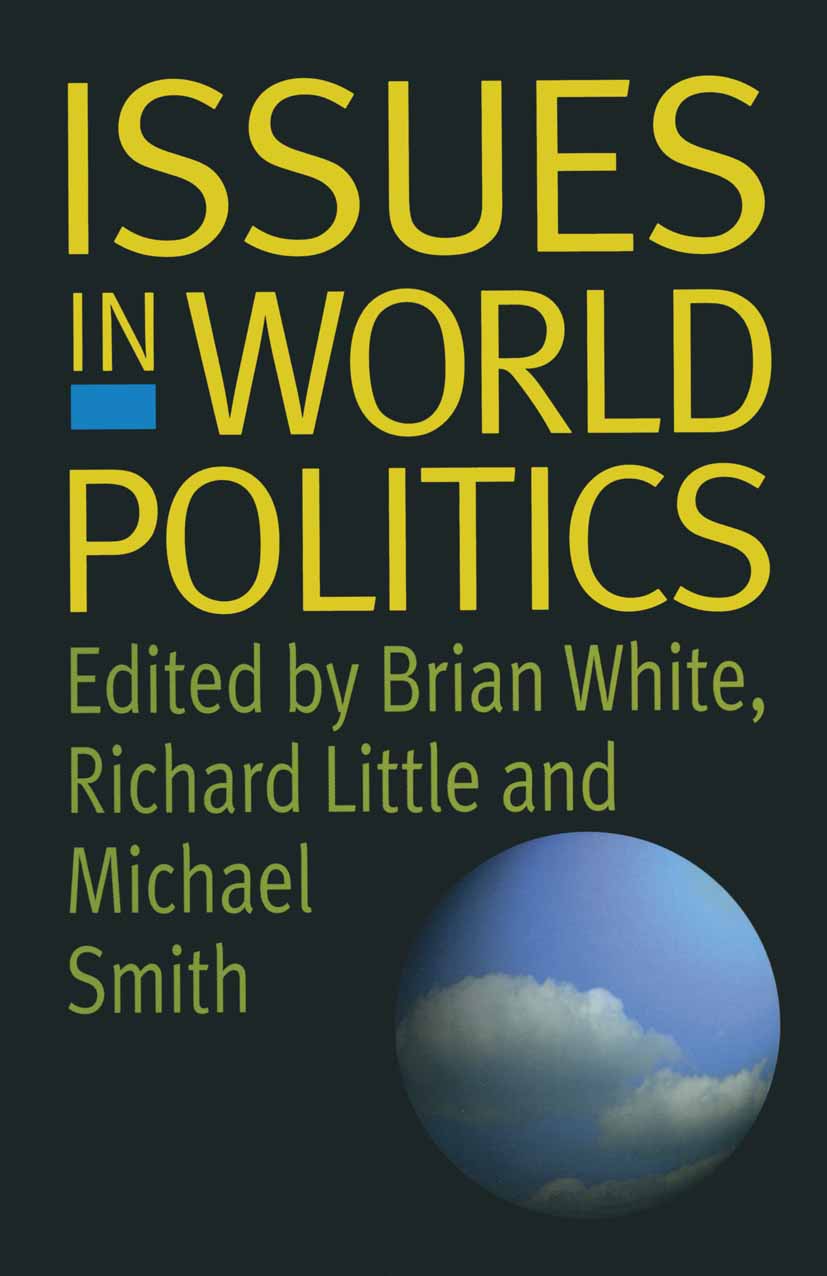
Issues in World Politics An edited introductory text in International Relations focusing centrally on key issues rather than theories, structures or processes. The aim is to build a bridge into the subject from students' interests in Current Affairs and thus to have particular appeal to the large numbers of students who do not go on to further study in International Relations. It will also be a useful complement to standard textbooks for those who do. POLITICAL SCIENCE,International Relations,General
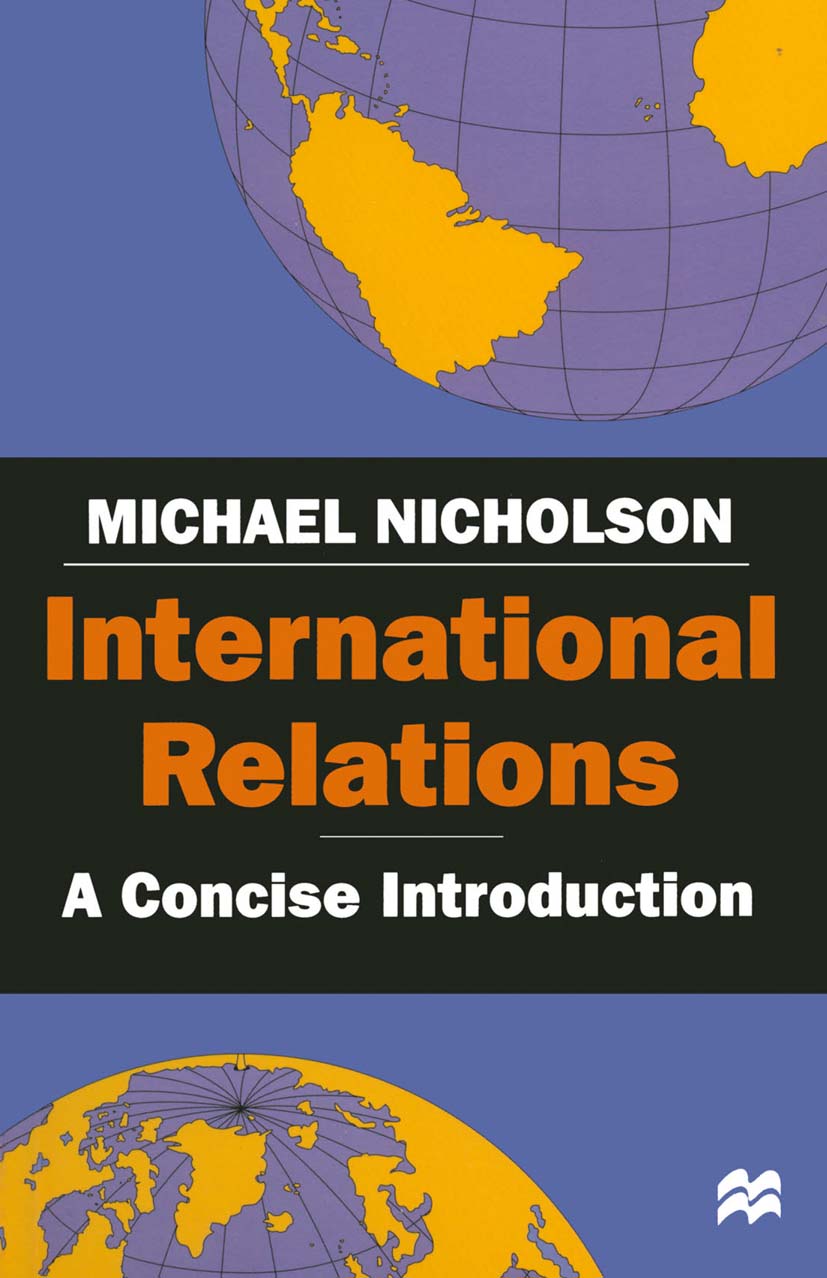
International Relations This concise introductory text has been written for students beginning International Relations or requiring a brief but comprehensive overview. The book outlines key current theories, approaches and controversies and stresses the relationship between the theory of international relations and the realities of the international system, both historically, and as it faces the challenge of an increasingly globalized post-Cold War world. POLITICAL SCIENCE,International Relations,General
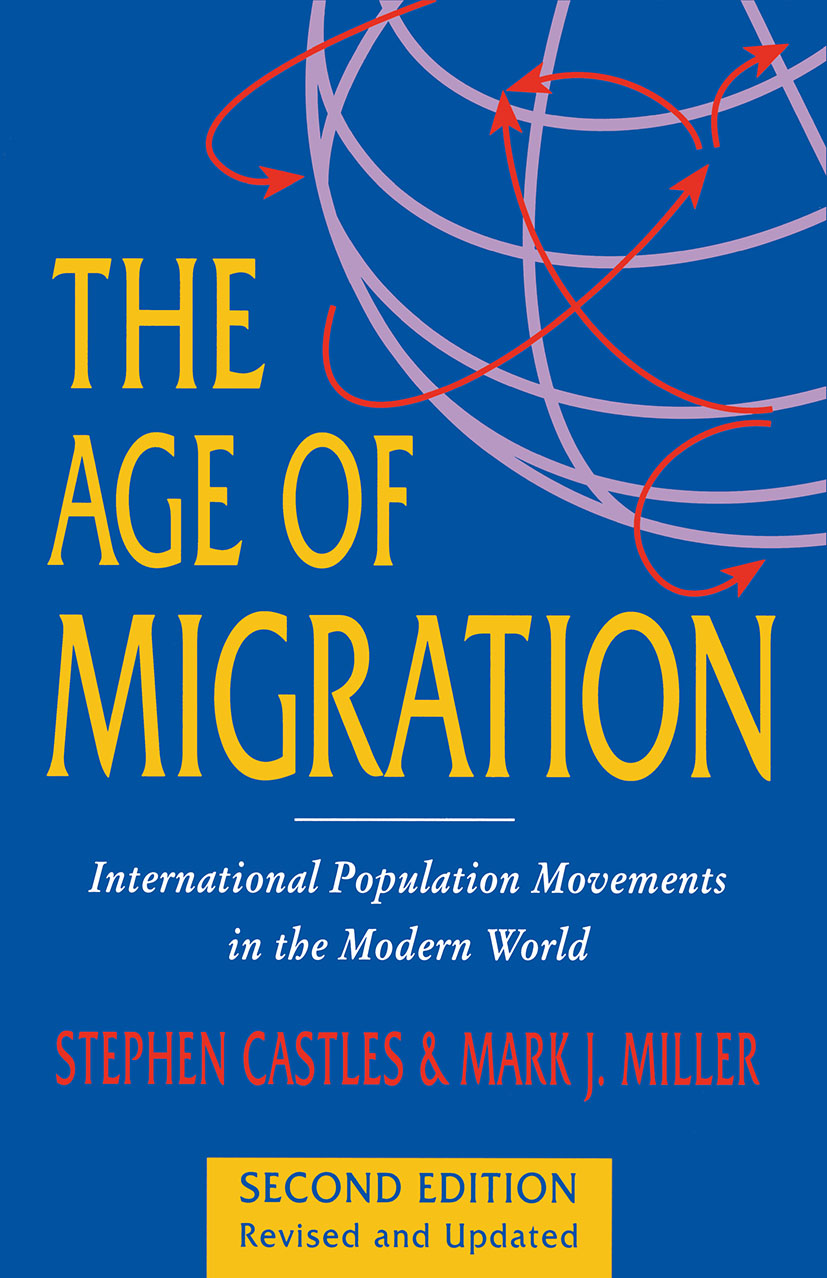
The Age of Migration At the dawn of the twenty-first century, international migration has become a major factor in economic and political change. Millions of people move as workers, settlers or refugees, affecting all regions of the world. The new cultural diversity is challenging national borders and identity. The Age of Migration analyses population movements and their consequences on a global level. The second edition has been completely revised and updated with substantially increased coverage of new migrations in Africa, Latin America and Asia. POLITICAL SCIENCE,International Relations,General
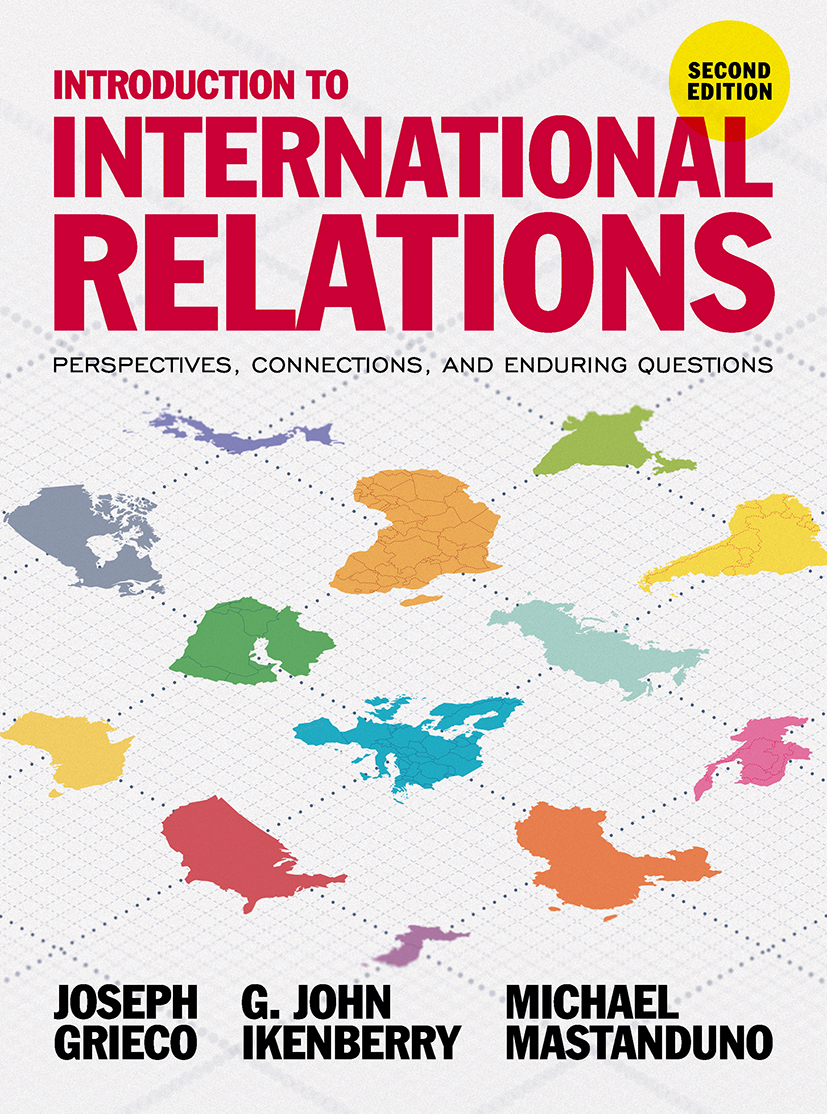
Introduction to International Relations The hotly awaited second edition of this bestselling introductory textbook provides a truly comprehensive and accessible guide to international affairs. Bringing together the combined decades of experience in researching and teaching global politics of three acclaimed scholars, this text introduces students to what is happening in our complex and rapidly changing world as well as how to analyse those events. Pedagogically driven, the book is structured around enduring questions that reflect the key concepts in world politics. It makes use of the levels of analysis framework and boxed features to highlight connections between theory and practice, aspirations and reality and history and contemporary events. This fully updated second edition includes a brand new chapter on International Organizations, a new feature to give students an insight into the latest academic research, and has been extensively rewritten throughout. This is an ideal textbook for introductory modules for Political Science and International Relations undergraduate students. POLITICAL SCIENCE,International Relations,General

Rethinking Global Governance Rethinking Global Governance provides a survey of extent and institutions of global governance today. It steers a path between those who are unrealistically utopian about global governance and those who are unduly pessimistic about ever achieving it. Instead, by setting global governance in historical context and looking at progress in specific issue areas, it provides a clear and grounded account of the prospects and possibilities for global governance. POLITICAL SCIENCE,International Relations,General

The SAGE Handbook of Political Science Comprising three volumes of contributions from expert authors from around the world, The SAGE Handbook of Political Science aims to frame, assess and synthesize research in the field, helping to define and identify its current and future developments. POLITICAL SCIENCE,International Relations,General
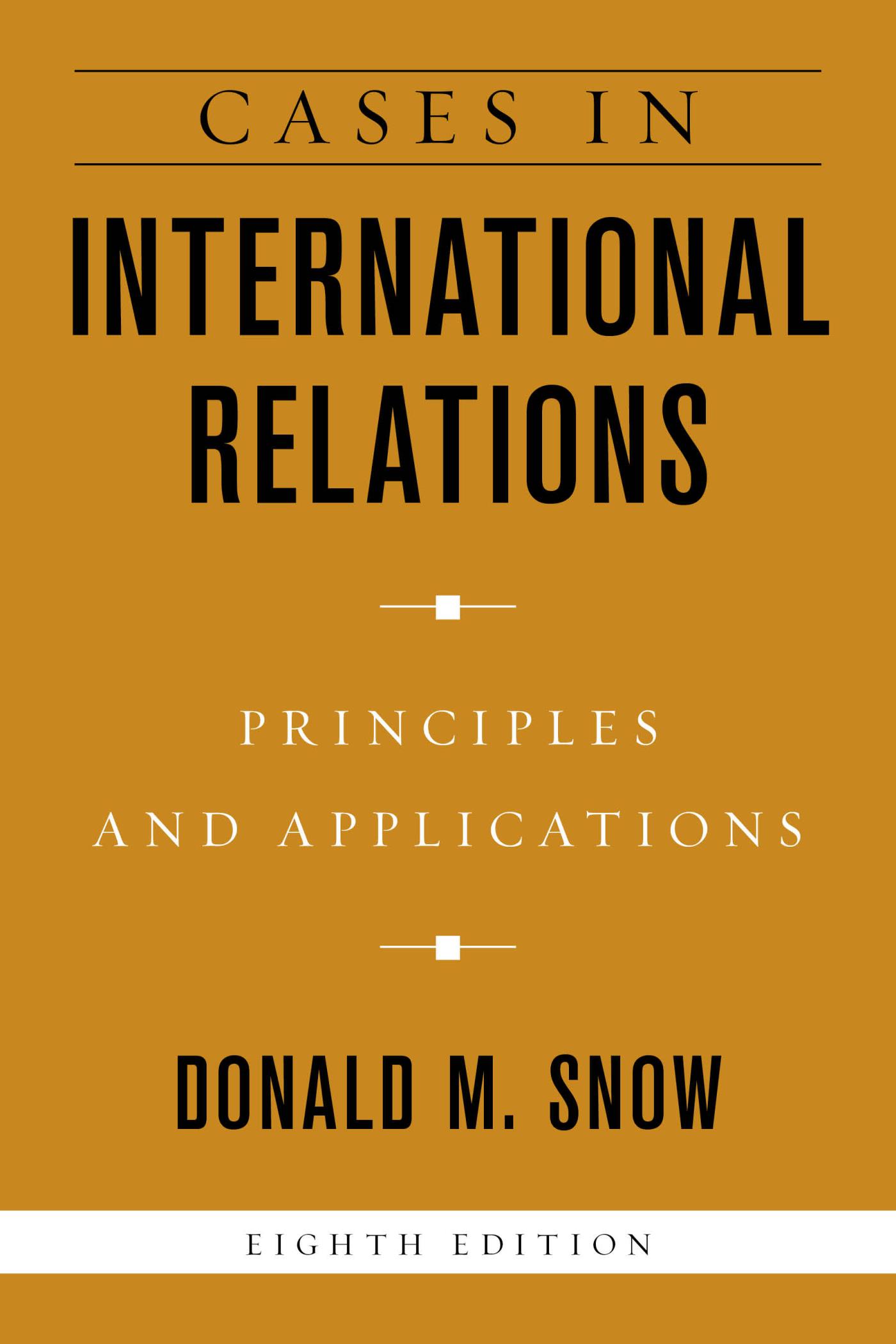
Cases in International Relations Designed to complement the main themes of any introductory course, Snow’s bestselling text presents original case studies that survey the state of the international system and look in-depth at issues of current interest. POLITICAL SCIENCE,International Relations,General

International Relations Today, more than ever, we live in a global world. Whether it’s war, economics, politics, or law, our lives are influenced by a complex web of cross-border transactions. Dr Charles Jones ably provides the building blocks to understand these interactions, outlining the competing theories that attempt to explain them. Arguing that the strength of International Relations lies in its contradictions – it’s not a single discipline but a fascinating mess of history, politics, economics, sociology, law, anthropology, and cultural studies – he provides a lively discussion of the limitations of the field, but also why it is so essential. Covering conflict, history, and theory, and with a major focus on the global economy, this is the perfect primer for aspiring students of International Relations, workers in an international context, and citizens across the globe. POLITICAL SCIENCE,International Relations,General
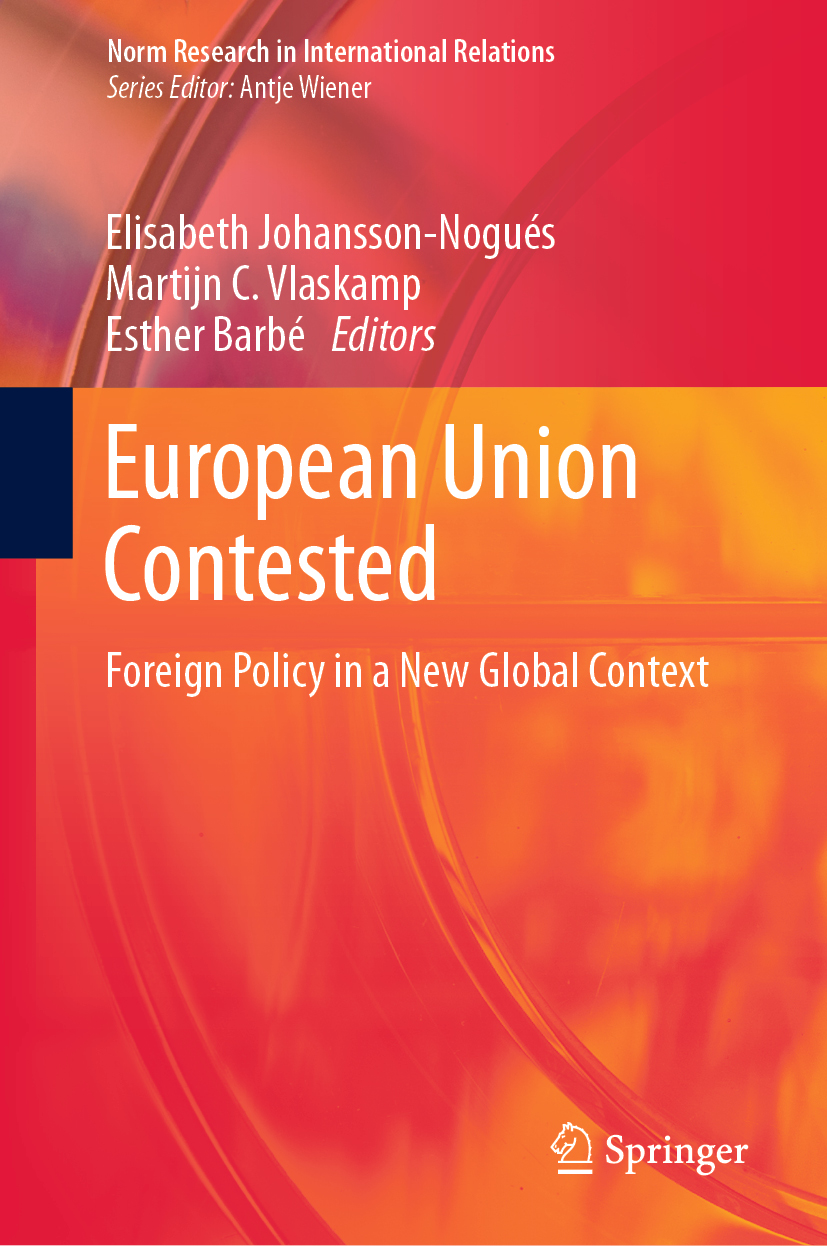
European Union Contested The European Union's foreign policy and its international role are increasingly being contested both globally and at home. At the global level, a growing number of states are now challenging the Western-led liberal order defended by the EU. Large as well as smaller states are vying for more leeway to act out their own communitarian principles on and approaches to sovereignty, security and economic development. At the European level, a similar battle has begun over principles, values and institutions. The most vocal critics have been anti-globalization movements, developmental NGOs, and populist political parties at both extremes of the left-right political spectrum. This book, based on ten case studies, explores some of the most important current challenges to EU foreign policy norms, whether at the global, glocal or intra-EU level. The case studies cover contestation of the EU's fundamental norms, organizing principles and standardized procedures in relation to the abolition of the death penalty, climate, Responsibility to Protect, peacebuilding, natural resource governance, the International Criminal Court, lethal autonomous weapons systems, trade, the security-development nexus and the use of consensus on foreign policy matters in the European Parliament. The book also theorizes the current norm contestation in terms of the extent to, and conditions under which, the EU foreign policy is being put to the test. POLITICAL SCIENCE,International Relations,General
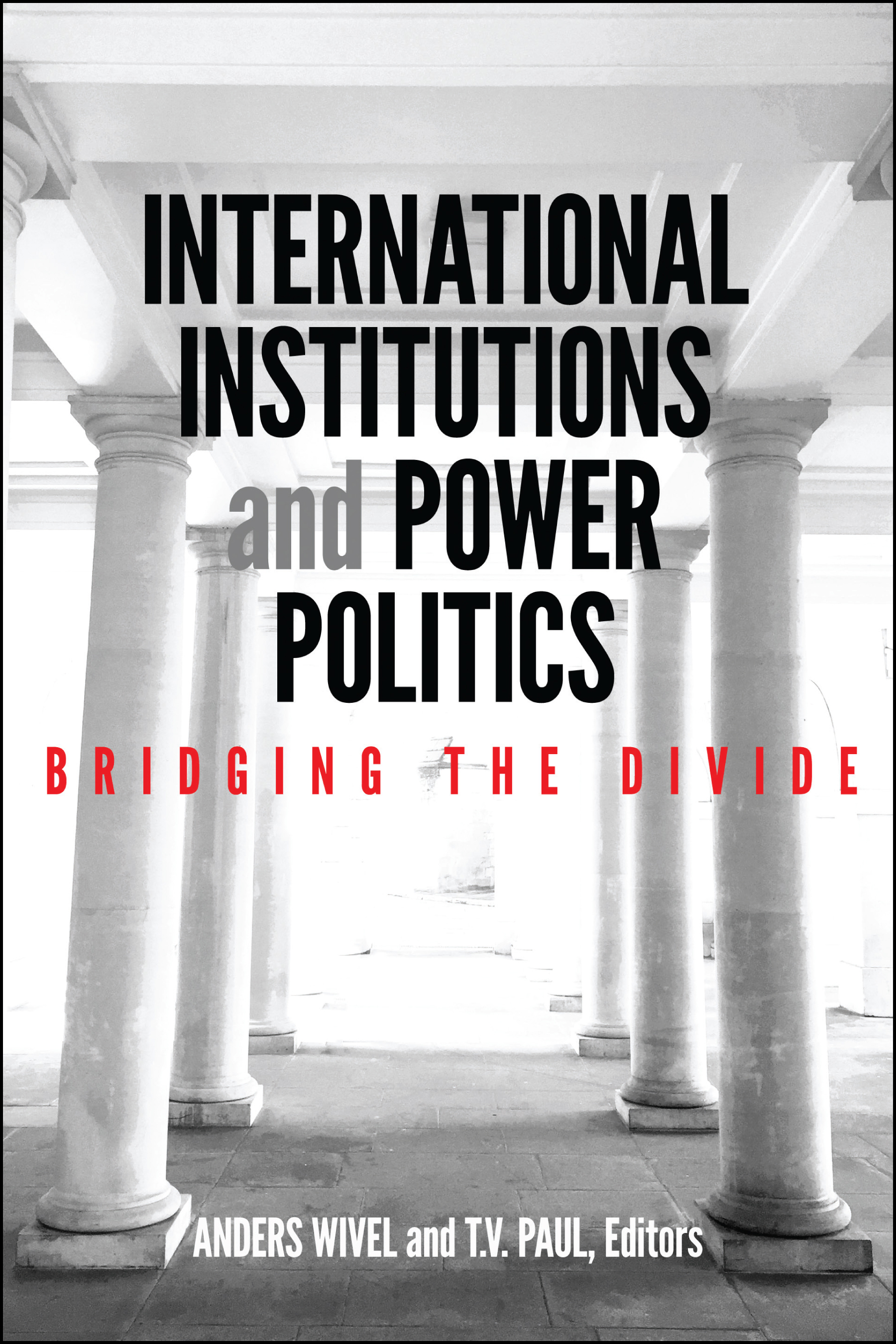
International Institutions and Power Politics This book moves scholarly debates beyond the old question of whether or not international institutions matter in order to examine how they matter, even in a world of power politics. Power politics and international institutions are often studied as two separate domains, but this is in need of rethinking because today most states strategically use institutions to further their interests. Anders Wivel, T.V. Paul, and the international group of contributing authors update our understanding of how institutions are viewed among the major theoretical paradigms in international relations, and they seek to bridge the divides. Empirical chapters examine specific institutions in practice, including the United Nations, International Atomic Energy Agency, and the European Union. The book also points the way to future research. International Institutions and Power Politics provides insights for both international relations theory and practical matters of foreign affairs, and it will be essential reading for all international relations scholars and advanced students. POLITICAL SCIENCE,International Relations,General

Global Issues 2020 Edition CQ Researcher’s Global Issues offers an in-depth and nuanced look at a wide range of today’s most pressing issues. The 2020 edition of this annual reader looks at new topics that peak student interest that are relevant in today's current events, including changes in U.S. foreign policy, tensions within the European Union, cryptocurrency, the 5G revolution, global fishing controversies, and the rise in extreme weather events. And because it’s CQ Researcher, the reports are expertly researched and written. Each chapter identifies the key players, explores what’s at stake, and offers the background and analysis necessary to understand how past and current developments impact the future of each issue. POLITICAL SCIENCE,International Relations,General

Perspectives on International Relations Henry R. Nau’s best-selling book, Perspectives on International Relations, is admired for its even-handed presentation of realism, liberalism, constructivism, and critical theory and for integrating these perspectives in every chapter. Students are able to explore the ways these different perspectives shape our understanding of the root causes of historical events and current controversies, and then think critically about the world’s most urgent issues. The new Seventh Edition includes updates on Brexit, the rise of nationalism, the escalation of terrorism, the use of social media in political protests around the world, and continuing developments in North Korea, Syria, Iran, China, and Russia. POLITICAL SCIENCE,International Relations,General
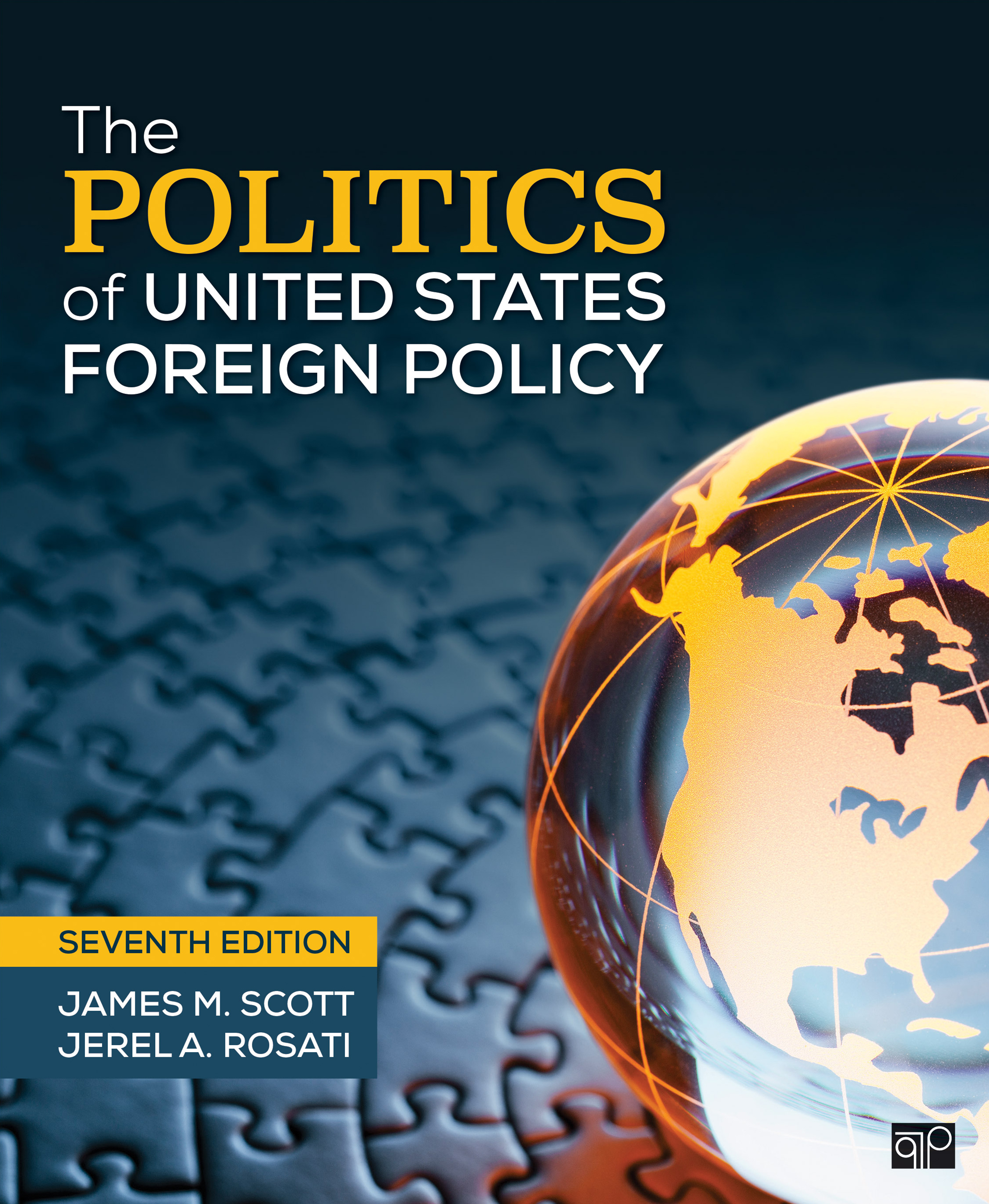
The Politics of United States Foreign Policy What are the factors that shape and determine the foreign policy choices of the United States? The Politics of United States Foreign Policy helps students consider the players, processes, and politics that drive U.S. decisions and involvement in foreign policy. James Scott and Jerel Rosati emphasize that society, government, and global forces have a role to play in the struggle over competing values when it comes to foreign policymaking. The book discusses historical patterns, the president’s ability to influence both at home and abroad, and the tension between democracy and national security. Now at CQ Press, the Seventh Edition has been updated to cover developments since the end of the Obama administration, the transition to the Trump administration, the challenges of changing international and domestic contexts, and the increasingly partisan political environment. The authors provide a comprehensive text that blends substance, theory, and stimulating analysis. POLITICAL SCIENCE,International Relations,General

The World Economic Forum and Transnational Networking The World Economic Forum and Transnational Networking presents an informative investigation of the WEF as a political actor and important part of transnational civil society. Drawing upon extensive original research, Frisen analyzes the surprising role the WEF has played in international processes. POLITICAL SCIENCE,International Relations,General
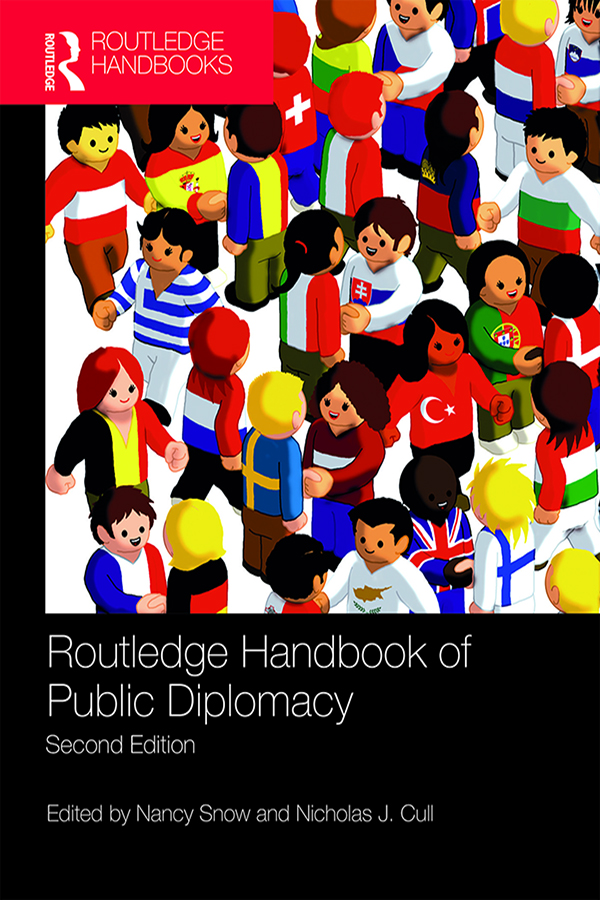
Routledge Handbook of Public Diplomacy The second edition of the Routledge Handbook of Public Diplomacy, co-edited by two leading scholars in the international relations subfield of public diplomacy, includes 16 more chapters from the first. Ten years later, a new global landscape of public diplomacy has taken shape, with major programs in graduate-level public diplomacy studies worldwide. What separates this handbook from others is its legacy and continuity from the first edition. This first edition line-up was more military-focused than this edition, a nod to the work of Philip M. Taylor, to whom this updated edition is dedicated. This edition includes US content, but all case studies are outside the United States, not only to appeal to a global audience of scholars and practitioners, but also as a way of offering something fresher than the US/UK-centric competition. In Parts 1–4, original contributors are retained, many with revised editions, but new faces emerge. Parts 5 and 6 include 16 global case studies in public diplomacy, expanding the number of contributors by ten. The concluding part of the book includes chapters on digital and corporate public diplomacy, and a signature final chapter on the noosphere and noopolitik as they relate to public diplomacy. Designed for a broad audience, the Routledge Handbook of Public Diplomacy is encyclopedic in its range and depth of content, yet is written in an accessible style that will appeal to both undergraduate and postgraduate students. POLITICAL SCIENCE,International Relations,General
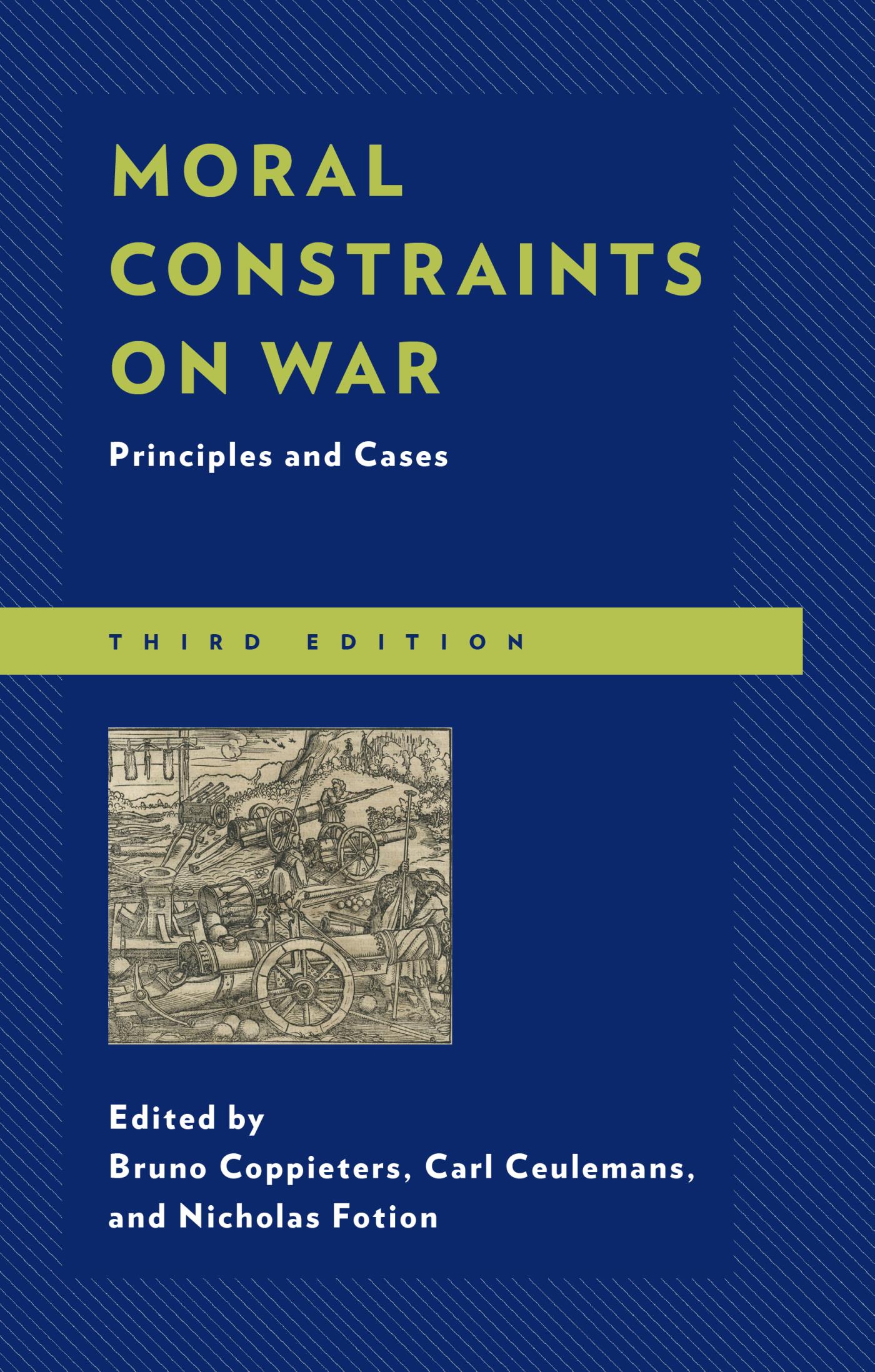
Moral Constraints on War This book seeks, in concrete historical terms, to deal with the issue of constraining war on the basis of moral principles as found in Just War Theory. As the book makes clear, this theory has its roots in transcultural experiences, concepts, and principles. POLITICAL SCIENCE,International Relations,General
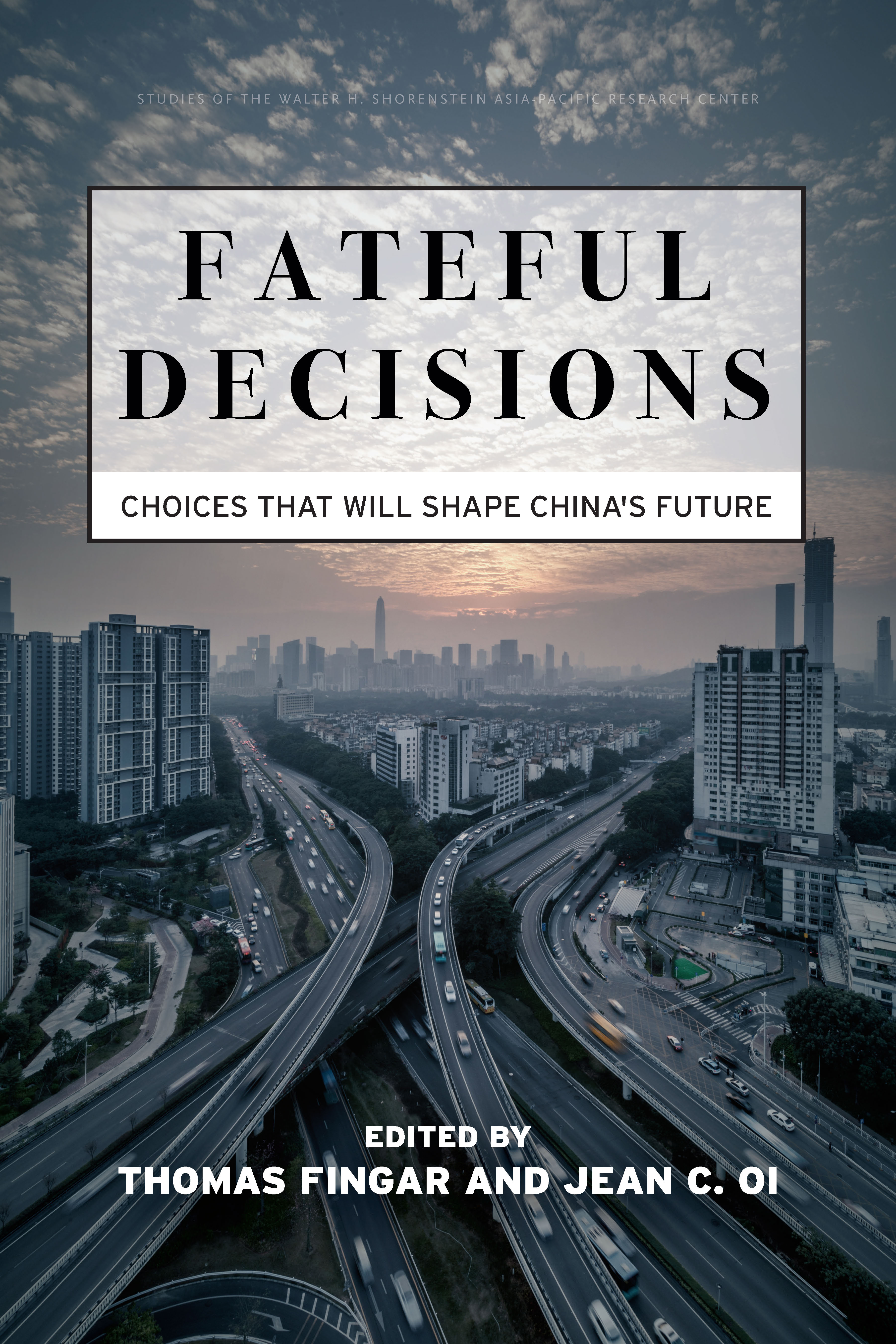
Fateful Decisions China's future is neither inevitable nor immutable: it will be shaped by the choices made to address the multiple interlinked challenges that it faces. POLITICAL SCIENCE,International Relations,General
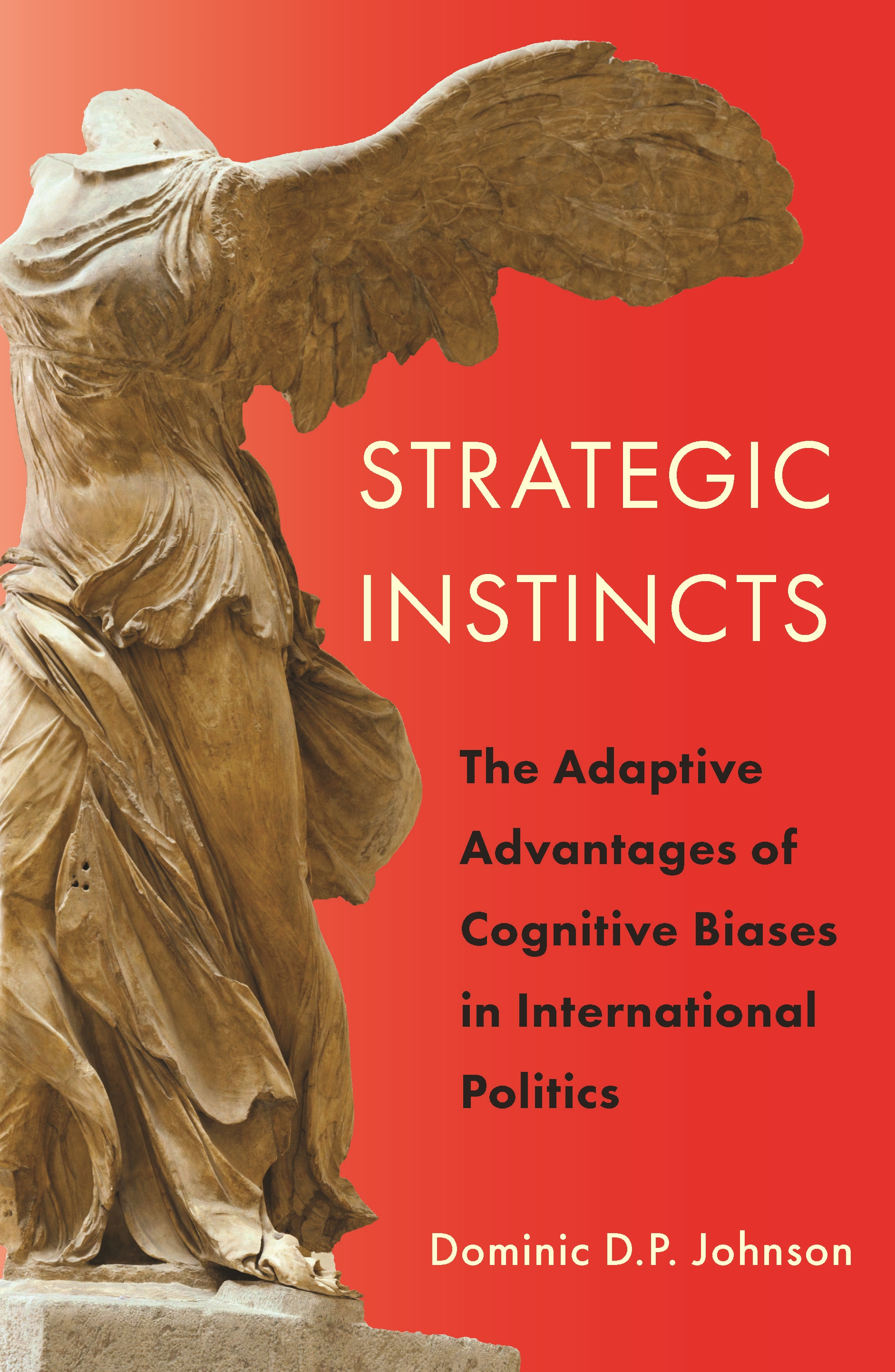
Strategic Instincts "A very timely book."—Anne-Marie Slaughter, CEO of New AmericaHow cognitive biases can guide good decision making in politics and international relations A widespread assumption in political science and international relations is that cognitive biases—quirks of the brain we all share as human beings—are detrimental and responsible for policy failures, disasters, and wars. In Strategic Instincts, Dominic Johnson challenges this assumption, explaining that these nonrational behaviors can actually support favorable results in international politics and contribute to political and strategic success. By studying past examples, he considers the ways that cognitive biases act as “strategic instincts,†lending a competitive edge in policy decisions, especially under conditions of unpredictability and imperfect information. Drawing from evolutionary theory and behavioral sciences, Johnson looks at three influential cognitive biases—overconfidence, the fundamental attribution error, and in-group/out-group bias. He then examines the advantageous as well as the detrimental effects of these biases through historical case studies of the American Revolution, the Munich Crisis, and the Pacific campaign in World War II. He acknowledges the dark side of biases—when confidence becomes hubris, when attribution errors become paranoia, and when group bias becomes prejudice. Ultimately, Johnson makes a case for a more nuanced understanding of the causes and consequences of cognitive biases and argues that in the complex world of international relations, strategic instincts can, in the right context, guide better performance. Strategic Instincts shows how an evolutionary perspective can offer the crucial next step in bringing psychological insights to bear on foundational questions in international politics. POLITICAL SCIENCE,International Relations,General

Advocating for Refugees in the European Union Advocating for Refugees in the European Union draws on different strands of theory in political science to examine how civil society groups use norm-based advocacy strategies to change the nature of the public and political debate surrounding refugee and asylum policy in five European countries and at the EU level. POLITICAL SCIENCE,International Relations,General

African Foreign Policies This book explores, at a time when several powers have become serious players on the continent, aspects of African agency, past and present, by African writers on foreign policy, representative of geography, language and state size. In the past, African foreign policy has largely been considered within the context of reactions to the international or global “external factorâ€. This groundbreaking book, however, looks at how foreign policy has been crafted and used in response not just to external, but also, mainly, domestic imperatives or (theoretical) signifiers. As such, it narrates individual and changing foreign policy orientations over time—and as far back as independence—with mainly African-based scholars who present their own constructs of what is a useful theoretical narrative regarding foreign policy on the continent—how theory is adapted to local circumstance or substituted for continentally based ontologies. The book therefore contends that the African experience carries valuable import for expanding general understandings of foreign policy in general. This book will be of key interest to scholars and students of Foreign Policy Analysis, Foreign Policy Studies, African International Relations/Politics/Studies, Diplomacy and more broadly to International Relations. POLITICAL SCIENCE,International Relations,General
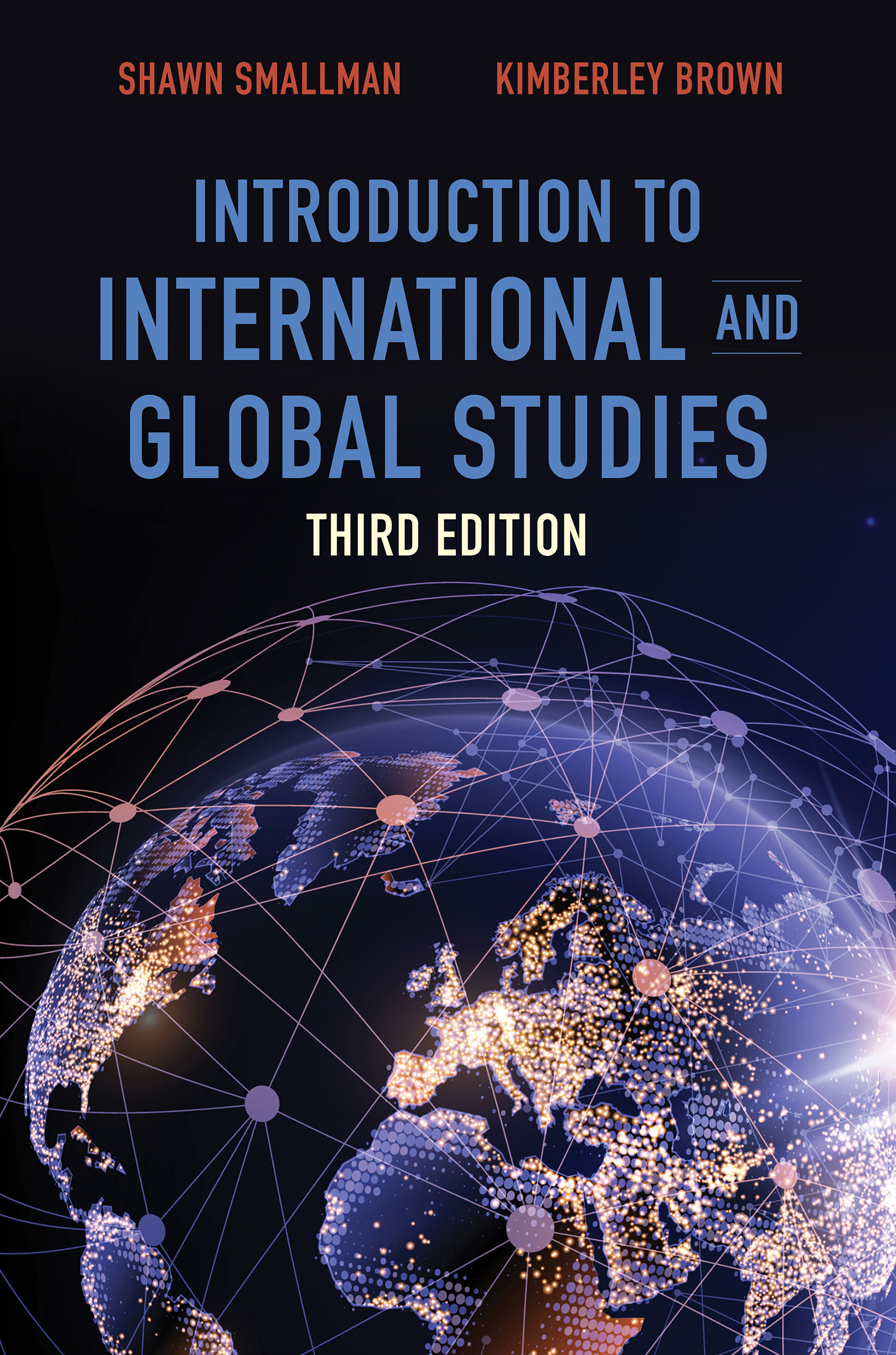
Introduction to International and Global Studies, Third Edition Shawn C. Smallman and Kimberley Brown's popular introductory textbook for undergraduates in international and global studies is now released in a substantially revised and updated third edition. Encompassing the latest scholarship in what has become a markedly interdisciplinary endeavor and an increasingly chosen undergraduate major, the book introduces key concepts, themes, and issues and then examines each in lively chapters on essential topics, including the history of globalization; economic, political, and cultural globalization; security, energy, and development; health; agriculture and food; and the environment. Within these topics the authors explore such diverse and pressing subjects as commodity chains, labor (including present-day slavery), pandemics, human rights, and multinational corporations and the connections among them. This textbook, used successfully in both traditional and online courses, provides the newest and most crucial information needed for understanding our rapidly changing world. New to this edition:*Close to 50% new material*New illustrations, maps, and tables*New and expanded emphases on political and economic globalization and populism; health; climate change, and development*Extensively revised exercises and activities*New resume-writing exercise in careers chapter*Thoroughly revised online teacher's manual POLITICAL SCIENCE,International Relations,General
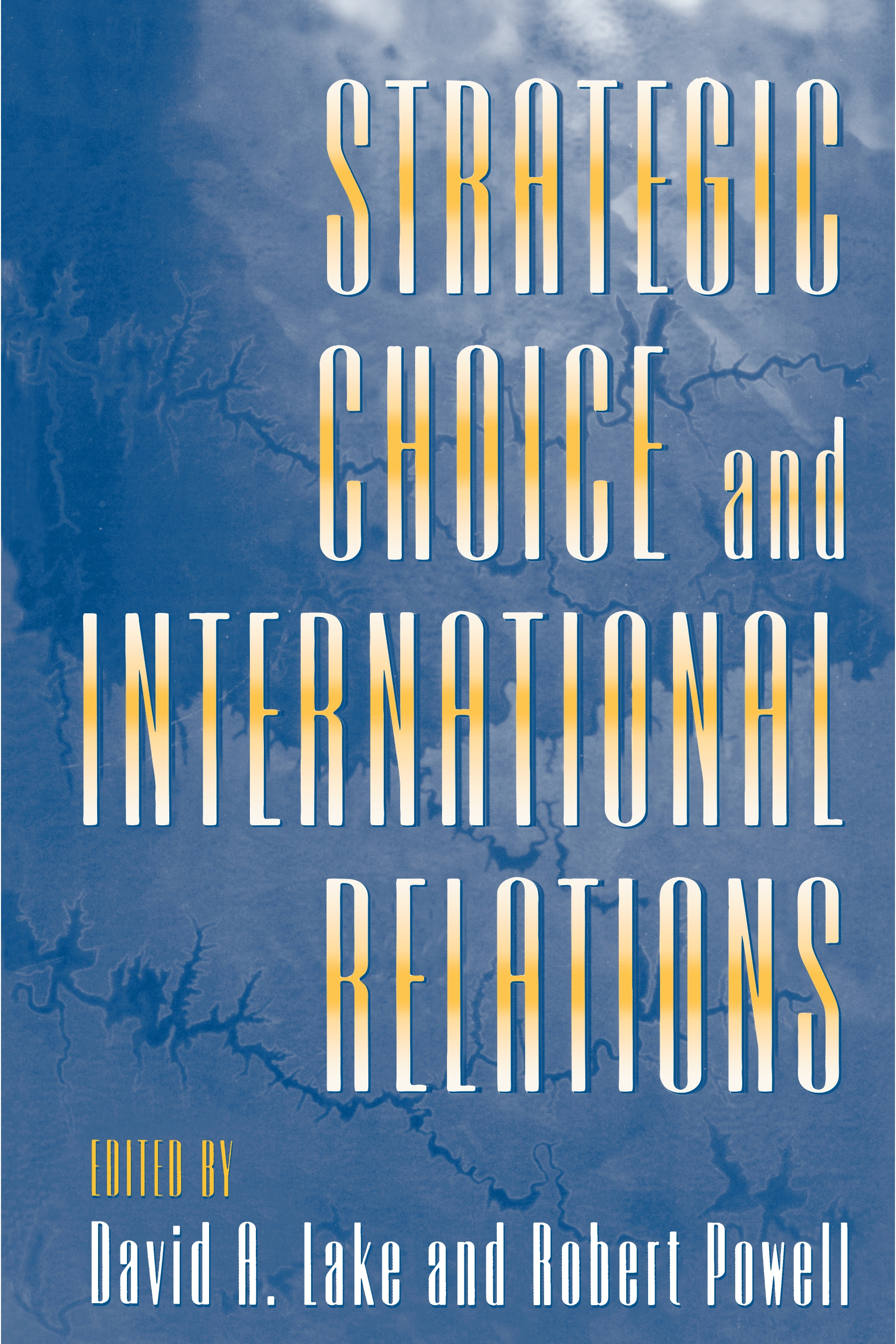
Strategic Choice and International Relations The strategic-choice approach has a long pedigree in international relations. In an area often rent by competing methodologies, editors David A. Lake and Robert Powell take the best of accepted and contested knowledge among many theories. With the contributors to this volume, they offer a unifying perspective, which begins with a simple insight: students of international relations want to explain the choices actors make--whether these actors be states, parties, ethnic groups, companies, leaders, or individuals. This synthesis offers three new benefits: first, the strategic interaction of actors is the unit of analysis, rather than particular states or policies; second, these interactions are now usefully organized into analytic schemes, on which conceptual experiments may be based; and third, a set of methodological "bets" is then made about the most productive ways to analyze the interactions. Together, these elements allow the pragmatic application of theories that may apply to a myriad of particular cases, such as individuals protesting environmental degradation, governments seeking to control nuclear weapons, or the United Nations attempting to mobilize member states for international peacekeeping. Besides the editors, the six contributors to this book, all distinguished scholars of international relations, are Jeffry A. Frieden, James D. Morrow, Ronald Rogowski, Peter Gourevitch, Miles Kahler, and Arthur A. Stein. Their work is an invaluable introduction for scholars and students of international relations, economists, and government decision-makers. POLITICAL SCIENCE,International Relations,General

Strong Societies and Weak States Why do many Asian, African, and Latin American states have such difficulty in directing the behavior of their populations--in spite of the resources at their disposal? And why do a small number of other states succeed in such control? What effect do failing laws and social policies have on the state itself? In answering these questions, Joel Migdal takes a new look at the role of the state in the third world. Strong Societies and Weak States offers a fresh approach to the study of state-society relations and to the possibilities for economic and political reforms in the third world. In Asia, Africa, and Latin America, state institutions have established a permanent presence among the populations of even the most remote villages. A close look at the performance of these agencies, however, reveals that often they operate on principles radically different from those conceived by their founders and creators in the capital city. Migdal proposes an answer to this paradox: a model of state-society relations that highlights the state's struggle with other social organizations and a theory that explains the differing abilities of states to predominate in those struggles. POLITICAL SCIENCE,International Relations,General

Useful Adversaries This book provides a new analysis of why relations between the United States and the Chinese Communists were so hostile in the first decade of the Cold War. Employing extensive documentation, it offers a fresh approach to long-debated questions such as why Truman refused to recognize the Chinese Communists, why the United States aided Chiang Kai-shek's KMT on Taiwan, why the Korean War escalated into a Sino-American conflict, and why Mao shelled islands in the Taiwan Straits in 1958, thus sparking a major crisis with the United States. Christensen first develops a novel two-level approach that explains why leaders manipulate low-level conflicts to mobilize popular support for expensive, long-term security strategies. By linking "grand strategy," domestic politics, and the manipulation of ideology and conflict, Christensen provides a nuanced and sophisticated link between domestic politics and foreign policy. He then applies the approach to Truman's policy toward the Chinese Communists in 1947-50 and to Mao's initiation of the 1958 Taiwan Straits Crisis. In these cases the extension of short-term conflict was useful in gaining popular support for the overall grand strategy that each leader was promoting domestically: Truman's limited-containment strategy toward the USSR and Mao's self-strengthening programs during the Great Leap Forward. Christensen also explores how such low-level conflicts can escalate, as they did in Korea, despite leaders' desire to avoid actual warfare. POLITICAL SCIENCE,International Relations,General
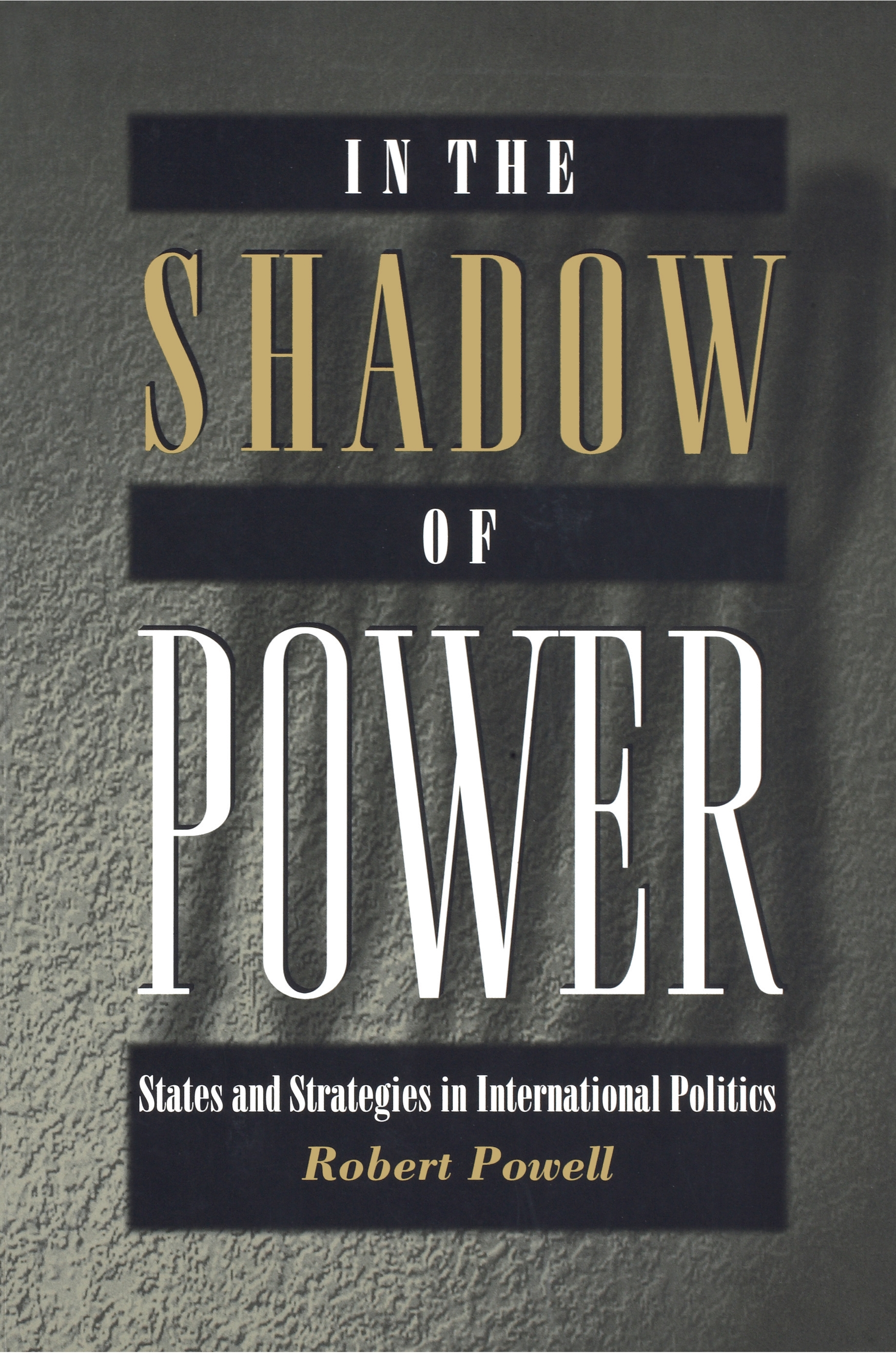
In the Shadow of Power Robert Powell argues persuasively and elegantly for the usefulness of formal models in studying international conflict and for the necessity of greater dialogue between modeling and empirical analysis. Powell makes it clear that many widely made arguments about the way states act under threat do not hold when subjected to the rigors of modeling. In doing so, he provides a more secure foundation for the future of international relations theory. Powell argues that, in the Hobbesian environment in which states exist, a state can respond to a threat in at least three ways: (1) it can reallocate resources already under its control; (2) it can try to defuse the threat through bargaining and compromise; (3) it can try to draw on the resources of other states by allying with them. Powell carefully outlines these three responses and uses a series of game theoretic models to examine each of them, showing that the models make the analysis of these responses more precise than would otherwise be possible. The advantages of the modeling-oriented approach, Powell contends, have been evident in the number of new insights they have made possible in international relations theory. Some argue that these advances could have originated in ordinary-language models, but as Powell notes, they did not in practice do so. The book focuses on the insights and intuitions that emerge during modeling, rather than on technical analysis, making it accessible to readers with only a general background in international relations theory. POLITICAL SCIENCE,International Relations,General

Ordinary People in Extraordinary Times For generations, influential thinkers--often citing the tragic polarization that took place during Germany's Great Depression--have suspected that people's loyalty to democratic institutions erodes under pressure and that citizens gravitate toward antidemocratic extremes in times of political and economic crisis. But do people really defect from democracy when times get tough? Do ordinary people play a leading role in the collapse of popular government? Based on extensive research, this book overturns the common wisdom. It shows that the German experience was exceptional, that people's affinity for particular political positions are surprisingly stable, and that what is often labeled polarization is the result not of vote switching but of such factors as expansion of the franchise, elite defections, and the mobilization of new voters. Democratic collapses are caused less by changes in popular preferences than by the actions of political elites who polarize themselves and mistake the actions of a few for the preferences of the many. These conclusions are drawn from the study of twenty cases, including every democracy that collapsed in the aftermath of the Russian Revolution in interwar Europe, every South American democracy that fell to the Right after the Cuban Revolution, and three democracies that avoided breakdown despite serious economic and political challenges. Unique in its historical and regional scope, this book offers unsettling but important lessons about civil society and regime change--and about the paths to democratic consolidation today. POLITICAL SCIENCE,International Relations,General
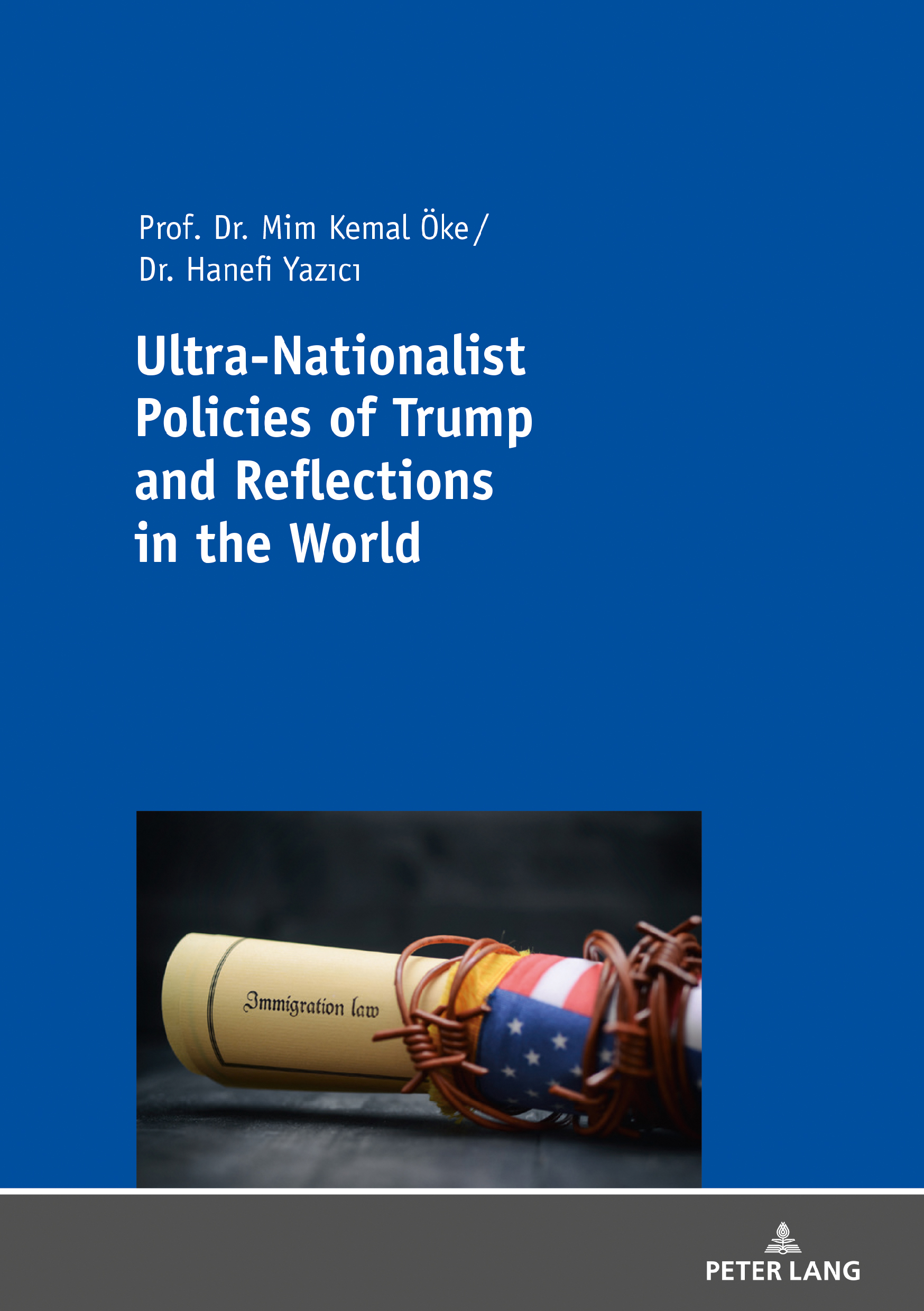
Ultra-Nationalist Policies of Trump and Reflections in the World The main aim of this book is to evaluate the US foreign policy during the Trump era and its ultra-nationalism within the context of its influence on the major actors and regions at the international level. The authoritarian dimension of the Trump administration’s policy will be the supportive element of the framework of this book. POLITICAL SCIENCE,International Relations,General
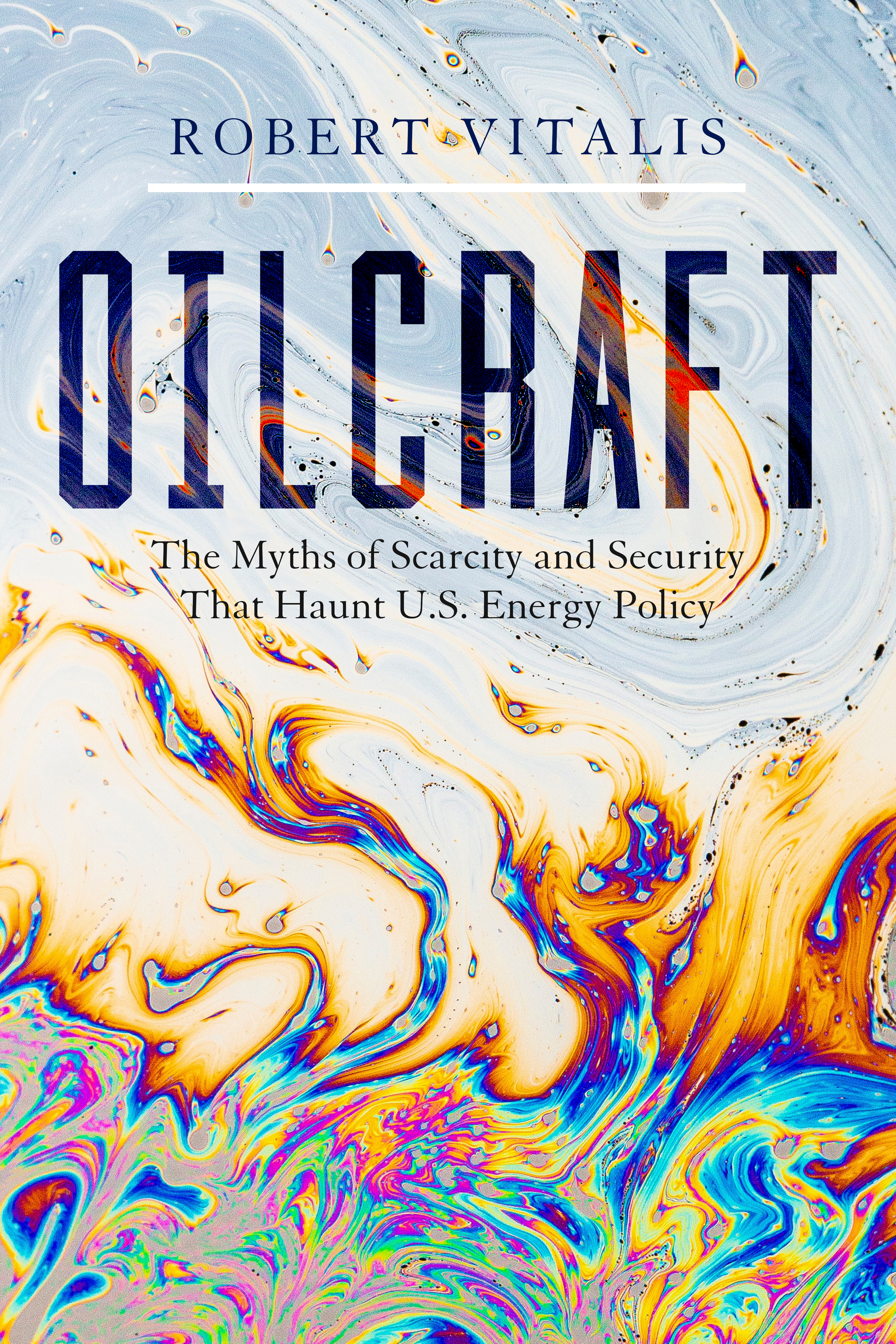
Oilcraft A bracing corrective to the myths that have shaped economic, military, and diplomatic policy, dispelling our oil-soaked fantasies of dependence. There is a conventional wisdom about oil—that the U.S. military presence in the Persian Gulf is what guarantees access to this strategic resource; that the "special" relationship with Saudi Arabia is necessary to stabilize an otherwise volatile market; and that these assumptions in turn provide Washington enormous leverage over Europe and Asia. Except, the conventional wisdom is wrong. Robert Vitalis debunks the myths to reveal "oilcraft," a line of magical thinking closer to witchcraft than statecraft. Oil is a commodity like any other: bought, sold, and subject to market forces. Thus, the first goal of this book is to expose the suspect fears of oil scarcity and conflict. The second goal is to investigate the significant geopolitical impact of these false beliefs. In particular, Vitalis shows how we can reconsider the question of the U.S.–Saudi special relationship, which confuses and traps many into unnecessarily accepting what they imagine is a devil's bargain. The House of Saud does many things for U.S. investors, firms, and government agencies, but guaranteeing the flow of oil, making it cheap, or stabilizing the price isn't one of them. Freeing ourselves from the spell of oilcraft won't be easy—but the benefits make it essential. POLITICAL SCIENCE,International Relations,General

International Trade and Political Conflict This book unveils a potent new approach to one of the oldest debates in political economy--that over whether class conflict or group competition is more prevalent in politics. It goes further than any study to date by outlining the conditions under which one type of political conflict is more likely than the other. Michael Hiscox focuses on a critical issue affecting support for and opposition to free trade--factor mobility, or the ability of those who own a factor of production (land, labor, or capital) to move it from one industry to another. He argues that the types of political coalitions that form in trade politics depend largely on the extent to which factors are mobile between industries. Class coalitions are more likely where factor mobility is high, Hiscox demonstrates, whereas narrow, industry-based coalitions predominate where it is low. The book also breaks new ground by backing up the theory it advances with systematic evidence from the history of trade politics in six nations over the last two centuries, using a combination of case studies and quantitative analysis. It makes fresh conclusions about the forces shaping trade policy outcomes--conclusions that yield surprising insights into the likely evolution of the global trading system and U.S. trade policy in particular. International Trade and Political Conflict is a major contribution to the scholarly literature while being accessible to anyone interested in understanding and predicting developments in trade policy. POLITICAL SCIENCE,International Relations,General
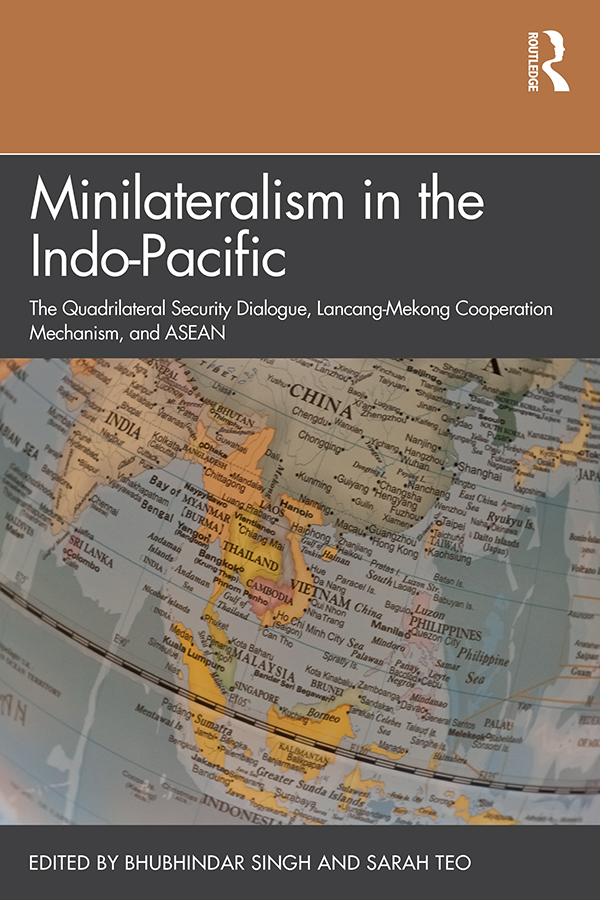
Minilateralism in the Indo-Pacific While US-centred bilateralism and ASEAN-led multilateralism have largely dominated the post-Cold War regional security architecture in the Indo-Pacific, increasing doubts about their effectiveness have resulted in countries turning to alternative forms of cooperation, such as minilateral arrangements. Compared to multilateral groupings, minilateral platforms are smaller in size, as well as more exclusive, flexible and functional. Both China and the US have contributed to minilateral initiatives in the Indo-Pacific. In the case of the former, there is the Lancang-Mekong Cooperation mechanism—involving China, Cambodia, Laos, Myanmar, Thailand and Vietnam—established in 2015. In the case of the latter, there has been a revival of the Quadrilateral Security Dialogue in 2017—involving the US, Australia, Japan and India. This book examines the rise of these arrangements, their challenges and opportunities, as well as their impact on the extant regional security architecture, including on the ASEAN-led multilateral order. A valuable guide for students and policy-makers looking to understand the nature and development of minilateralism in the Indo-Pacific region. POLITICAL SCIENCE,International Relations,General
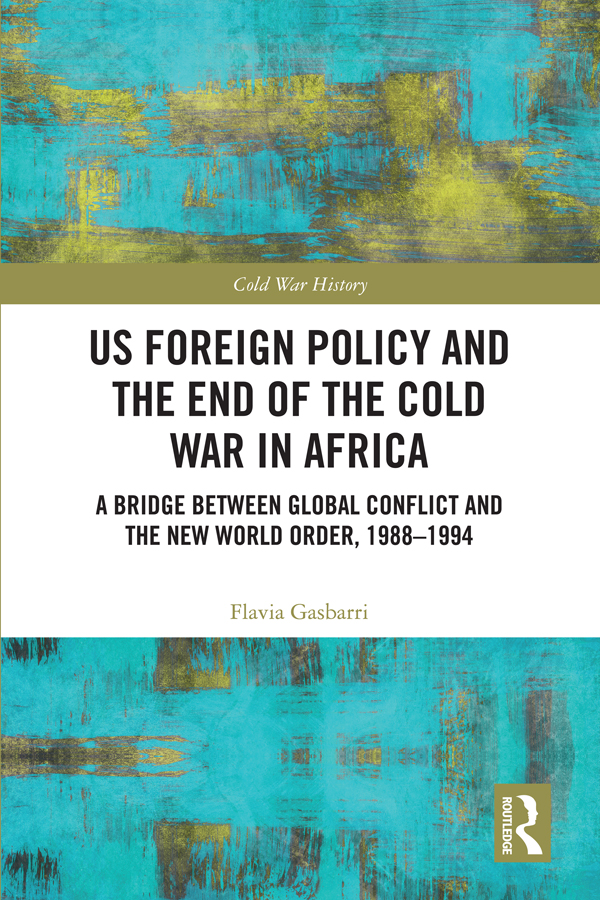
US Foreign Policy and the End of the Cold War in Africa This book investigates the end of the Cold War in Africa and its impact on post-Cold War US foreign policy in the continent. The fall of the Berlin Wall is widely considered the end of the Cold War; however, it documents just one of the many "ends", since the Cold War was a global conflict. This book looks at one of the most neglected extra-European battlegrounds, the African continent, and explores how American foreign policy developed in this region between the late 1980s and the early 1990s. Drawing on a wide range of recently disclosed documents, the book shows that the Cold War in Africa ended in 1988, preceding the fall of the Berlin Wall. It also reveals how, since then, some of the most controversial and inconsistent episodes of post-Cold War US foreign policy in Africa have been deeply rooted in the unique process whereby American rivalry with the USSR found its end in the continent. The book challenges the traditional narrative by presenting an original perspective on the study of the end of the Cold War and provides new insights into the shaping of US foreign policy during the so-called ‘unipolar moment’. This book will be of much interest to students of Cold War history, US foreign policy, African politics and international relations. POLITICAL SCIENCE,International Relations,General

India’s Foreign Policy Written by the foreign policy experts, this book develops frameworks and strategies for India's Foreign Policy to meet the emerging challenges and non-traditional threats in the new world order. POLITICAL SCIENCE,International Relations,General
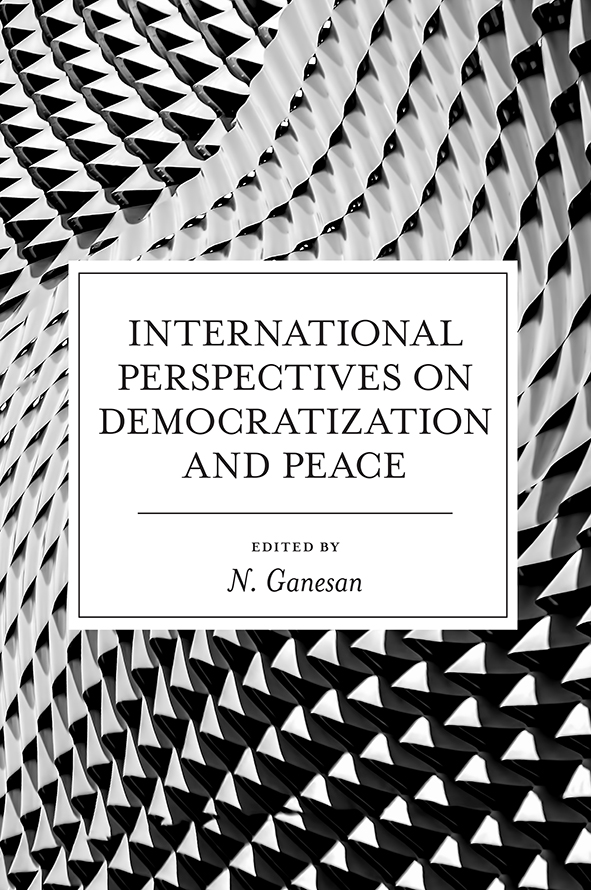
International Perspectives on Democratization and Peace This book examines the concept of peace and the relevance of historical and contextual factors that contribute to peaceful coexistence of people, and dives into a deep examination of how democracy furthers peace especially in conflict prone countries. Seven case studies illustrate the impact of democratization on transformation and prevention. POLITICAL SCIENCE,International Relations,General
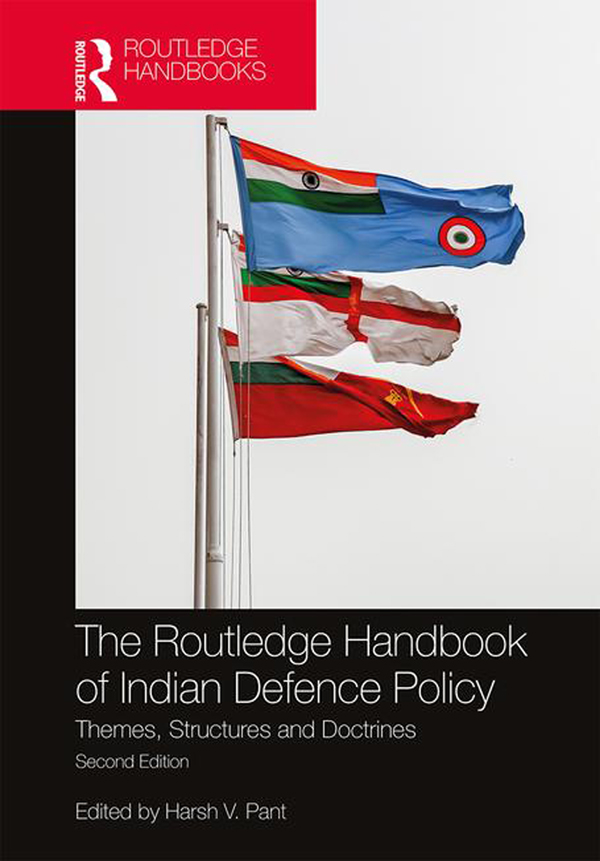
The Routledge Handbook of Indian Defence Policy The Routledge Handbook of Indian Defence Policy brings together the most eminent scholarship in South Asia on India’s defence policy and contemporary military history. It maps India’s political and military profile in South Asia and the Indian Ocean region, and analyses its emergence as a global player. This edition of the handbook: Canvasses over 60 years of Indian defence policy, its relation to India’s rising global economic profile, as well as foreign policy shifts; Discusses several key debates that have shaped defence strategies through the years: military doctrine and policy, internal and external security challenges, terrorism and insurgencies; Explores the origins of the modern armed forces in India; evolution of the army, navy and air forces; investments in professional military education, intelligence and net-centric warfare, reforms in paramilitary forces and the Indian police; Comments on India’s contemporary strategic interests, focusing on the rise of China, nuclearisation of India and Pakistan’s security establishments, and developments in space security and missile defence. Taking stock of India’s defence planning architecture over the past decade, this accessibly written handbook will be an indispensable resource for scholars and researchers of security and defence studies, international relations and political science, as well as for government thinktanks and policymakers. POLITICAL SCIENCE,International Relations,General
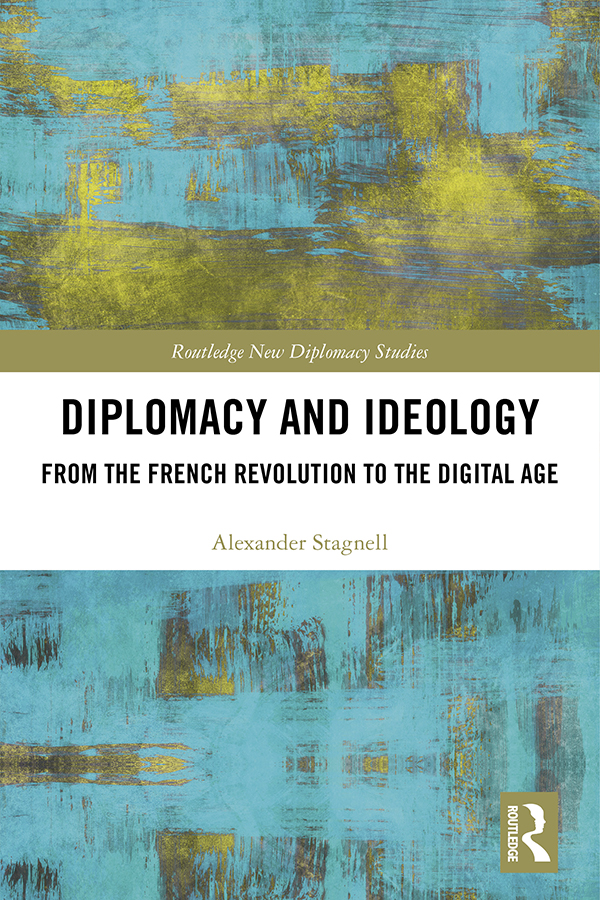
Diplomacy and Ideology This innovative new book argues that diplomacy, which emerged out of the French Revolution, has become one of the central Ideological State Apparatuses of the modern democratic nation-state. The book is divided into four thematic parts. The first presents the central concepts and theoretical perspectives derived from the work of Slavoj Žižek, focusing on his understanding of politics, ideology, and the core of the conceptual apparatus of Lacanian psychoanalysis. There then follow three parts treating diplomacy as archi-politics, ultra-politics, and post-politics, respectively highlighting three eras of the modern history of diplomacy from the French Revolution until today. The first part takes on the question of the creation of the term ‘diplomacy’, which took place during the time of the French Revolution. The second part begins with the effects on diplomacy arising from the horrors of the two World Wars. Finally, the third part covers another major shift in Western diplomacy during the last century, the fall of the Soviet Union, and how this transformation shows itself in the field of Diplomacy Studies. The book argues that diplomacy’s primary task is not to be understood as negotiating peace between warring parties, but rather to reproduce the myth of the state’s unity by repressing its fundamental inconsistencies. This book will be of much interest to students of diplomacy studies, political theory, philosophy, and International Relations. POLITICAL SCIENCE,International Relations,General

The False Promise of Liberal Order In an age of demagogues, hostile great powers and trade wars, foreign policy traditionalists dream of restoring liberal international order. This order, they claim, ushered in seventy years of peace and prosperity and saw post-war America domesticate the world to its values. The False Promise of Liberal Order exposes the flaws in this nostalgic vision. The world shaped by America came about as a result of coercion and, sometimes brutal, compromise. Liberal projects – to spread capitalist democracy – led inadvertently to illiberal results. To make peace, America made bargains with authoritarian forces. Even in the Pax Americana, the gentlest order yet, ordering was rough work. As its power grew, Washington came to believe that its order was exceptional and even permanent – a mentality that has led to spiralling deficits, permanent war and Trump. Romanticizing the liberal order makes it harder to adjust to today’s global disorder. Only by confronting the false promise of liberal order and adapting to current realities can the United States survive as a constitutional republic in a plural world. POLITICAL SCIENCE,International Relations,General

Speaking Private Authority Speaking Private Authority argues that to better understand the global governance phenomenon known as private authority, investigators must interrogate the strategic social maneuverings of actors—particularly how actors leverage discursive maneuverings to gain advantageous social positions to more effectively exercise private authority. POLITICAL SCIENCE,International Relations,General
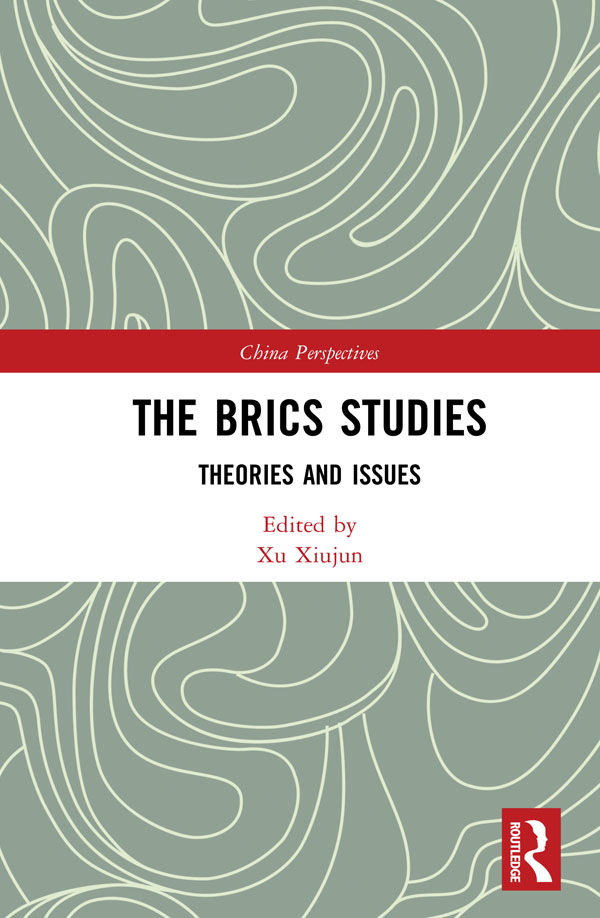
The BRICS Studies Given their immense potential for development and representation of a new international political and economic order, the BRICS countries have become a strong nascent force on the global stage. However, as overall economic growth continues to slow down, and the geopolitical situation becomes more complex, the BRICS countries are facing a series of new challenges that require further development in the way they cooperate with one another. This volume offers a panoramic view of cooperation between the BRICS countries in the light of these new challenges. The editors reveal that policy coordination has been strengthened, bringing into play complementary advantages as viable ways for promoting robust, sustainable, and balanced growth in the world economy. They argue that the experience gained, and lessons learned in the development of and cooperation between the BRICS countries has offered a positive role model for cooperation between other countries as well as providing valuable lessons for research in international politics. Students and scholars in international relations and politics will benefit from this volume. POLITICAL SCIENCE,International Relations,General
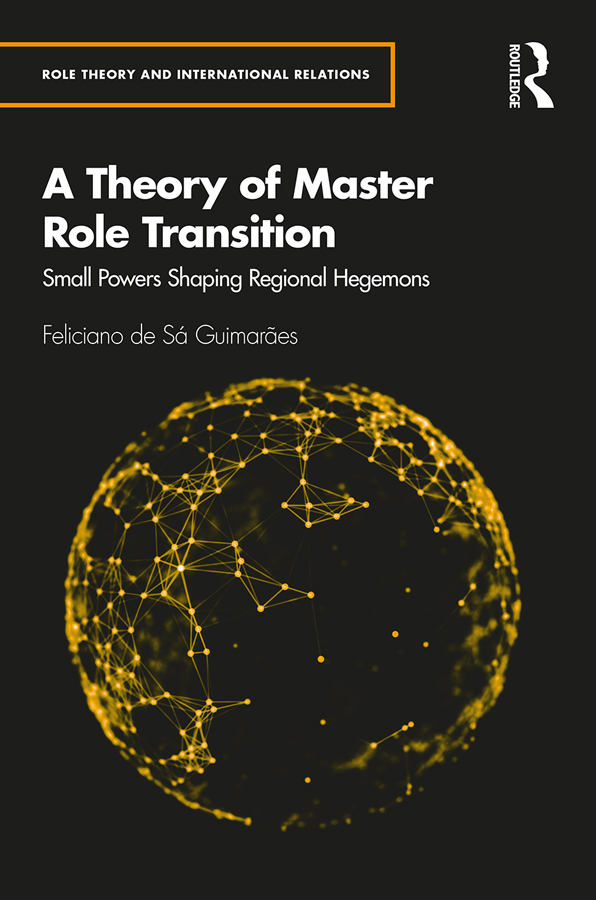
A Theory of Master Role Transition In this book, Feliciano de Sá Guimarães offers an original application of Role Theory. He proposes a theory of master role transitions to explain how small powers can change regional powers’ master roles without changing the regional material power distribution. Master role transition is the replacement of an active dominant master role by a dormant or inactive role located within one’s role repertoire. Guimarães argues that only a combination of four necessary conditions can produce a full master role transition: asymmetrical material interdependence, altercasting, domestic contestation and regional contestation. In each one of these conditions, a small power uses material and ideational tools to promote a master role transition within the regional power role repertoire. To test his model, Guimarães turns to five case studies in Latin America, Southern Africa and South Asia: the 2006–2007 Bolivia–Brazil gas crisis, the 2008–2009 Paraguay–Brazil Itaipú Dam crisis, the 2008–2009 Ecuador–Brazil Odebrecht crisis, the 1998 South Africa–Lesotho military intervention crisis and the 1996India–Bangladesh Ganges water crisis. A Theory of Master Role Transition is an excellent resource for those studying both theory and method in International Relations and foreign policy analysis. POLITICAL SCIENCE,International Relations,General

Killing for God Given the high cost of military operations, the author offers readers insights as to what motivates kingdoms, countries, and groups to engage in religious conflict. The insights of preeminent religious and political scholars are integrated into this analysis, leading to an answer to the question: Is the killing worth it? POLITICAL SCIENCE,International Relations,General

The Future of NATO Airpower Airpower remains the cornerstone of NATO’s military advantage, so maintaining the ability to win air superiority over peer opponents in a conflict is key to long-term deterrence stability in both Europe and the Pacific. This Whitehall Paper examines the various modernisation and future capability development efforts being undertaken within NATO, and analyses the major threat systems and overall modernisation trends of the West’s main peer-competitors – Russia and China. US airpower capability development efforts are increasingly focused on countering the growing challenge from the Chinese military in the Pacific. To meet this challenge, the Pentagon is planning to transform the way it operates across all domains over the next 15 years. New platforms, weapons systems and increasing automation of command and control threaten to leave NATO allies behind. Current acquisition and modernisation plans of European air forces may eventually close the capability gap with current US theatre entry standard capabilities, but by then the US will have leapt ahead once more. Furthermore, many of the airpower capabilities which the US is pursuing for the Pacific theatre are significantly less relevant for the demands of deterrence against Russia in Europe. Given continuing dependence on US enablers on the part of other NATO members, a significant divergence in capability plans threatens to undermine crucial Alliance interoperability if not recognised and managed early. POLITICAL SCIENCE,International Relations,General

Sports Diplomacy This book investigates the issue of sports diplomacy and refers to the place and role of sport within public diplomacy. Its subject includes the use of sport to shape relations with other states, to build the state’s international image and the diplomatic subjectivity of international sports organizations. POLITICAL SCIENCE,International Relations,General

Political Representation and Citizenship in Portugal This volume analyzes key dimensions of political representation and participation in Portugal, examining the impact of the economic crisis on the linkage between voters and elected representatives, contributing to assessing the significant changes that representative democracies have experienced and the factors that may boost their renewal. POLITICAL SCIENCE,International Relations,General
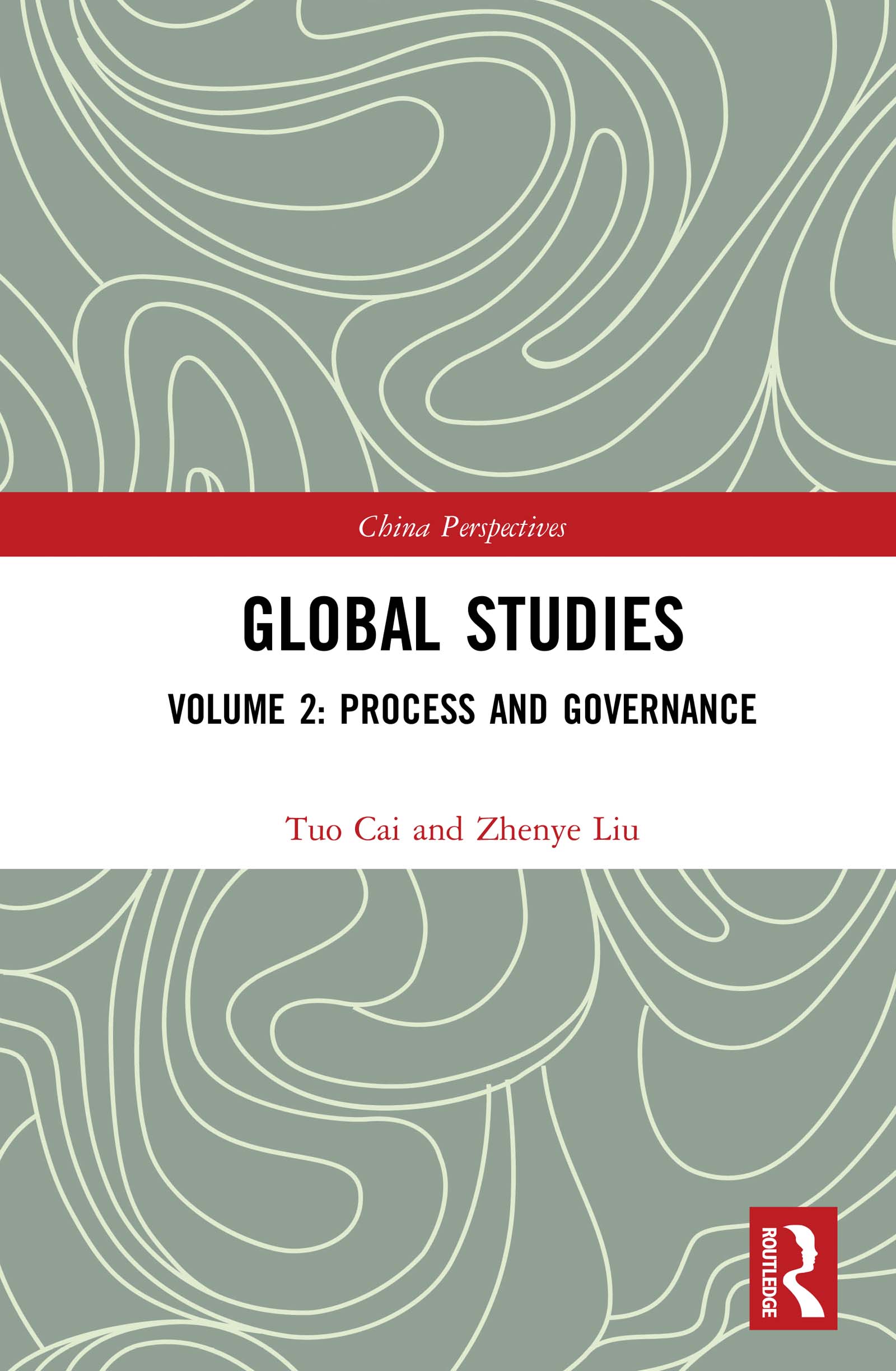
Global Studies Since the 1950s, globalization has been an increasingly irresistible trend and one that has exerted a tremendous impact on the political, economic, military, environmental, and social fortunes of mankind – and yet, existing theories in humanities and social sciences have been fundamentally built upon the traditional “nation-state†model. These two volumes, a pioneering work on global studies to be published out of China, aim at creating a new theoretical framework against the backdrop of globalization. This volume discusses globalization on the supranational level. The editors reveal the complexity of global studies by examining the multi-level and multi-dimensional nature of globalization, analyzing processes and systems of global society against the backdrop of globalization, and exploring the construction of a stable and rational global order. These two volumes are an essential reference for scholars and students in politics, economics, international relations, and law. POLITICAL SCIENCE,International Relations,General

Global Studies Since the 1950s, globalization has been an increasingly irresistible trend and one that has exerted a tremendous impact on the political, economic, military, environmental, and social fortunes of mankind – and yet, the existing theories in humanities and social sciences have been fundamentally built upon the traditional “nation-state†model. These two volumes, a pioneering work on global studies to be published out of China, aims at creating a new theoretical framework against the backdrop of globalization. This volume introduces core concepts and critical issues, deploying globalization as a theoretical framework and redefining the interrelationship between politics, economics, law, and globality. The two volumes are an essential reference for scholars and students in politics, economics, international relations, and law. POLITICAL SCIENCE,International Relations,General
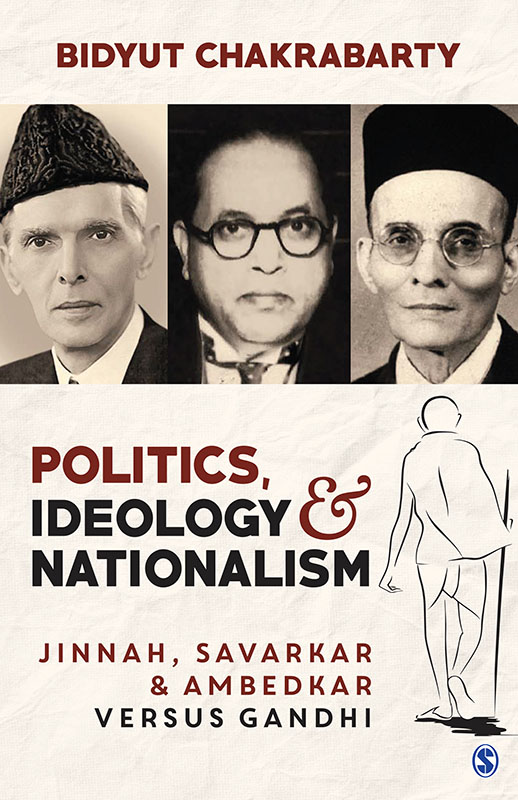
Politics, Ideology and Nationalism This is the first book which takes into account, Jinnah, Savarkar and Ambedkar, three notable personalities of the twentieth century solely with the purpose of analyzing their conflict with Gandhi. POLITICAL SCIENCE,International Relations,General
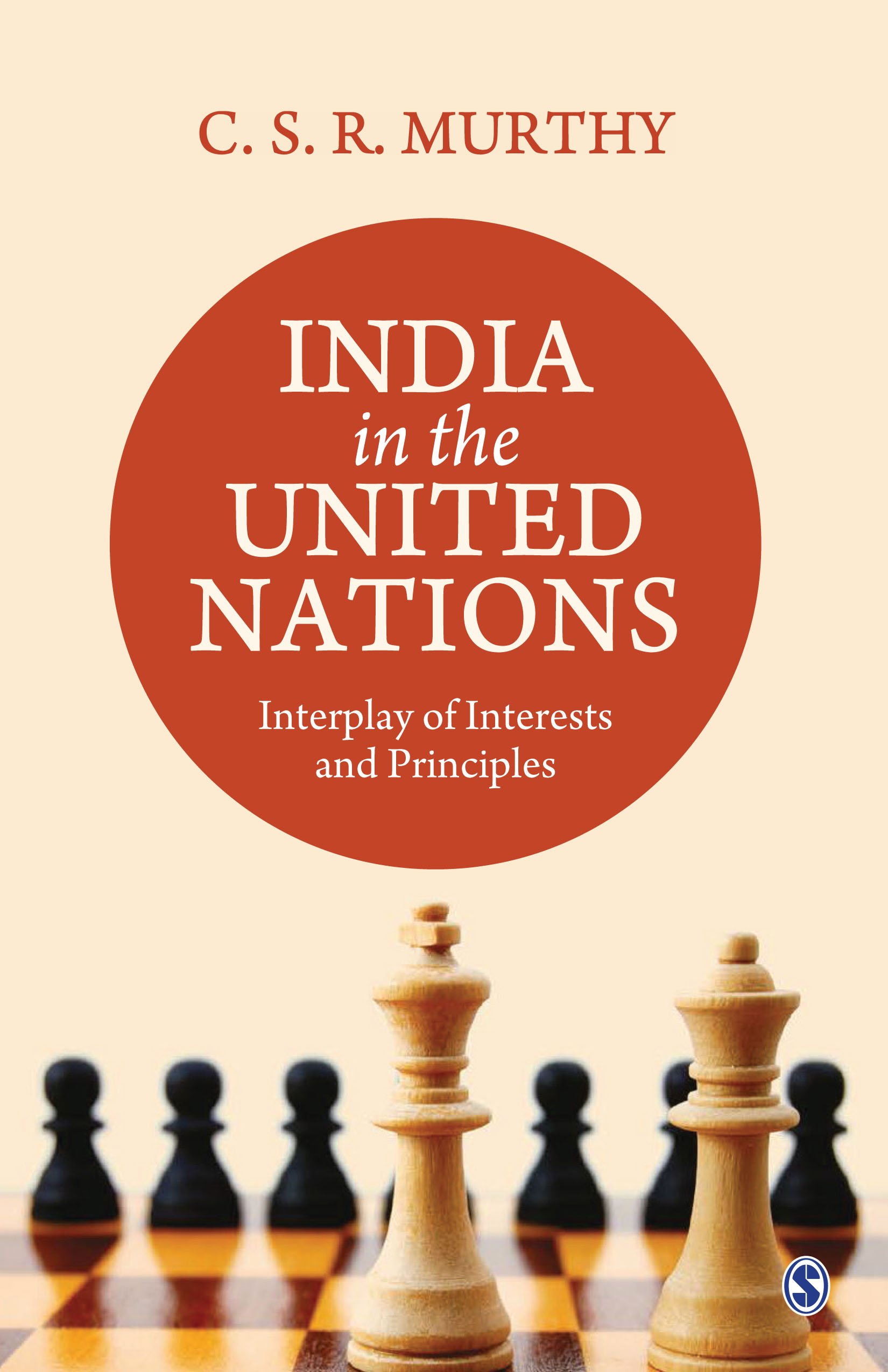
India in the United Nations This book examines India’s role in the UN from inception and evaluates key issues ranging from armed conflict, peacekeeping, terrorism, economic development, protection of human rights, and multilateral mode of internet governance. POLITICAL SCIENCE,International Relations,General
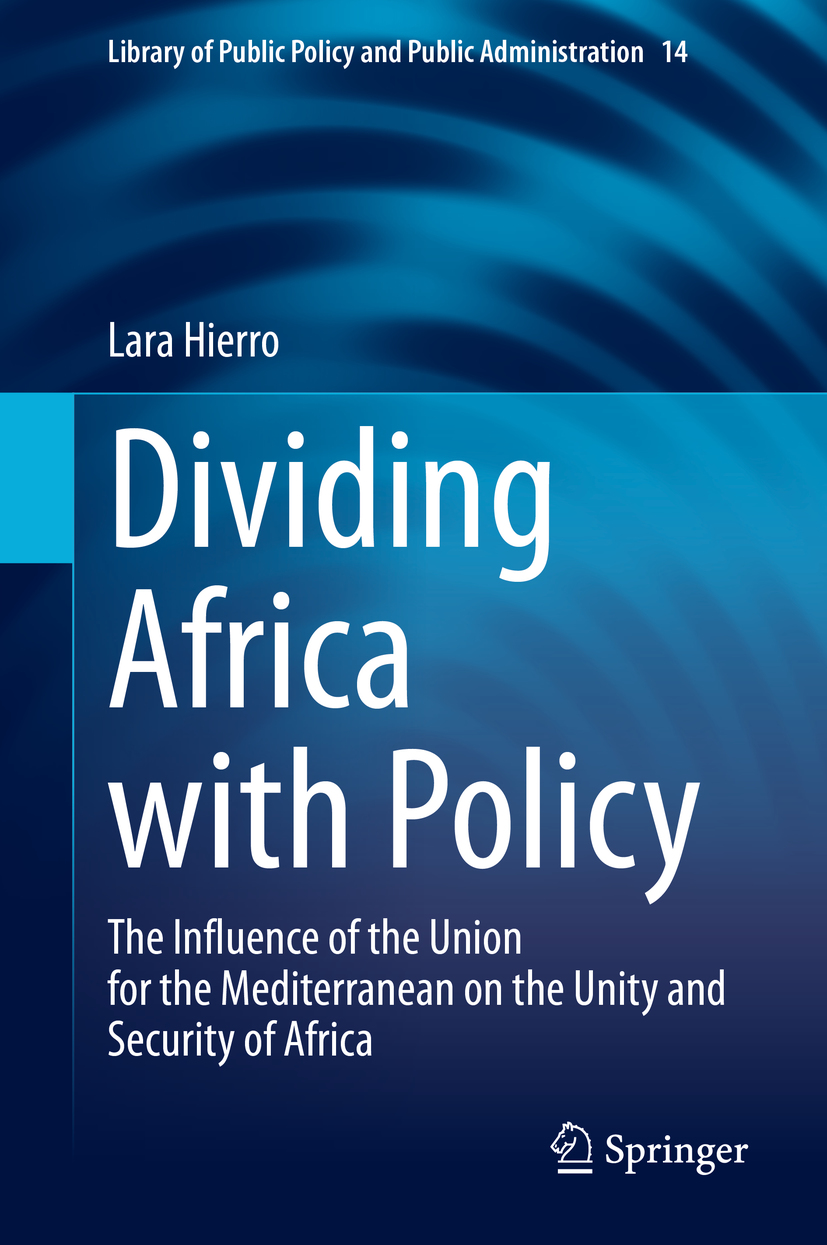
Dividing Africa with Policy This book addresses timely concerns of rising African nationalism and the 2nd decolonisation in Africa. The wholesale rejection of all things considered ‘Western’ is seen to be a result of ‘integrationalism’, defined as the specific kind of methodology by which EU foreign policy engagement may be interpreted. Using complexity theory and panarchy, a specific arrangement of interacting complex adaptive systems together with a ‘resilience assessment’, the EU’s foreign policy is shown to be undermining the aims of the premier African institution, the AU, created to provide unity and security on the continent: the EU pursues these objectives in its own image rather than honouring African values. This book raises awareness of these issues, as well as to widen the application of the theoretical framework in international relations and politics, which is becoming increasingly important in a complex world. The aim of this book is to show that the negative isolationism pursued in order to counteract western influence is not the answer and can be avoided through this awareness. POLITICAL SCIENCE,International Relations,General

Global Issues 2021 Edition Written by award-winning CQ Researcher journalists, this collection of non-partisan reports offers an in-depth examination of today’s most pressing global issues. With reports ranging from preparation for global pandemics, protest movements around the world, and environmental degradation, the 2021 Edition of Global Issues promotes in-depth discussion, facilitates further research, and helps readers formulate their own positions on crucial global issues. And because it’s CQ Researcher, the reports are expertly researched and written, presenting readers with all sides of an issue. POLITICAL SCIENCE,International Relations,General
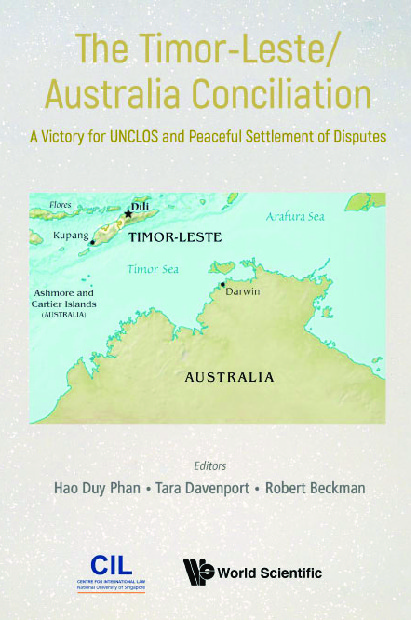
Timor-leste/australia Conciliation, The On 11 April 2016, Timor-Leste initiated a compulsory non-binding conciliation proceeding against Australia under Annex V of the United Nations Convention on the Law of the Sea (UNCLOS) on its maritime boundary dispute with Australia in the Timor Sea. On 6 March 2018, the parties signed a settlement treaty on the basis of the proposal of the Conciliation Commission. Two months later, the Conciliation Commission issued its report, marking the conclusion of the first ever conciliation proceeding under Annex V of UNCLOS.This book provides detailed analyses of the proceedings and a step-by-step account of the conciliation process, as well as its wider implications for dispute settlement under UNCLOS and beyond. The various chapters explore a wide range of issues, including an overview of conciliation as a means of dispute settlement and the conciliation procedure in UNCLOS, as well as the origins and historical background of the maritime boundary dispute between Timor-Leste and Australia. The book also provides a comprehensive examination of each step of the conciliation proceedings, including the role of the Conciliation Commission, the Conciliation Commission's Decision on Competence, the issue of joint development, and the Maritime Boundaries Treaty, which Timor-Leste and Australia concluded as the legal outcome of the conciliation proceedings. Critically, the book offers insightful perspectives from Australia and Timor-Leste on the conciliation process. The book is an important contribution to the research and analysis of the Timor Sea conciliation. As one of the first books on the case, it will raise awareness and bring more familiarity with conciliation as a viable and effective dispute settlement process, thereby encouraging states to consider conciliation as a means to settle their disputes. POLITICAL SCIENCE,International Relations,General
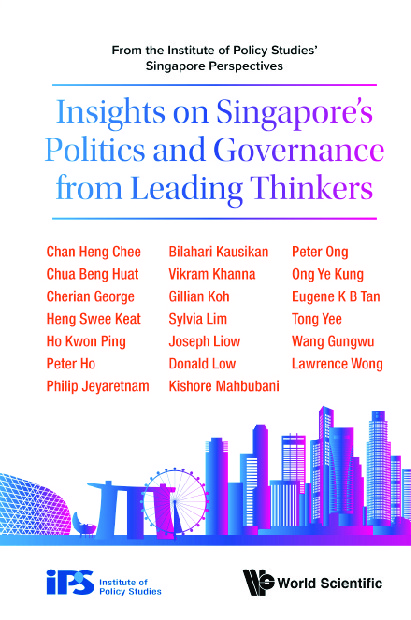
Insights On Singapore's Politics And Governance From Leading Thinkers This book presents insights on Singapore's politics and governance from leading thinkers, based on selected commentaries from Singapore Perspectives conference series co-published by Institute of Policy Studies and World Scientific. Contributed by the who's who of Singapore's government, business and academia circles, they provide diverse viewpoints over state-society relations, governing principles, electoral politics, foreign policy, among other important issues.Will consensus or contest secure Singapore's future? Should pragmatism be retained as Singapore's governing philosophy? What if the nation-state is no longer the key organisational unit of the international community? What if Singapore has to choose between China and the United States? What if Singapore becomes a two- or multi-party system? This volume explores a range of possible answers to these questions and more. POLITICAL SCIENCE,International Relations,General
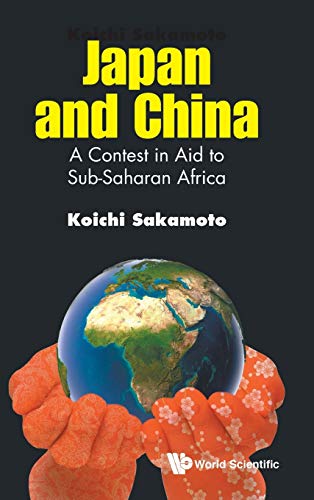
Japan And China Since the opening up of China in 1979, the country had experienced phenomenal economic growth over the decades and overtook Japan as the second-largest economy in 2010. With the establishment of a conservative administration led by Shinzo Abe in December 2012 and Xi Jinping's ascendance to power as the General Secretary of China's ruling party a month earlier, the two countries intensified their commitments in aid to Sub-Saharan Africa. Surveying the Japanese and Chinese aid in Sub-Saharan Africa, this book examines the two Asian giants' policies and achievements in past decades and discusses future directions of their aid initiatives. Japan and China: A Contest in Aid to Sub-Saharan Africa is recommended for those interested in understanding East Asian international relations and contemporary aid trends and issues in Sub-Saharan Africa. POLITICAL SCIENCE,International Relations,General
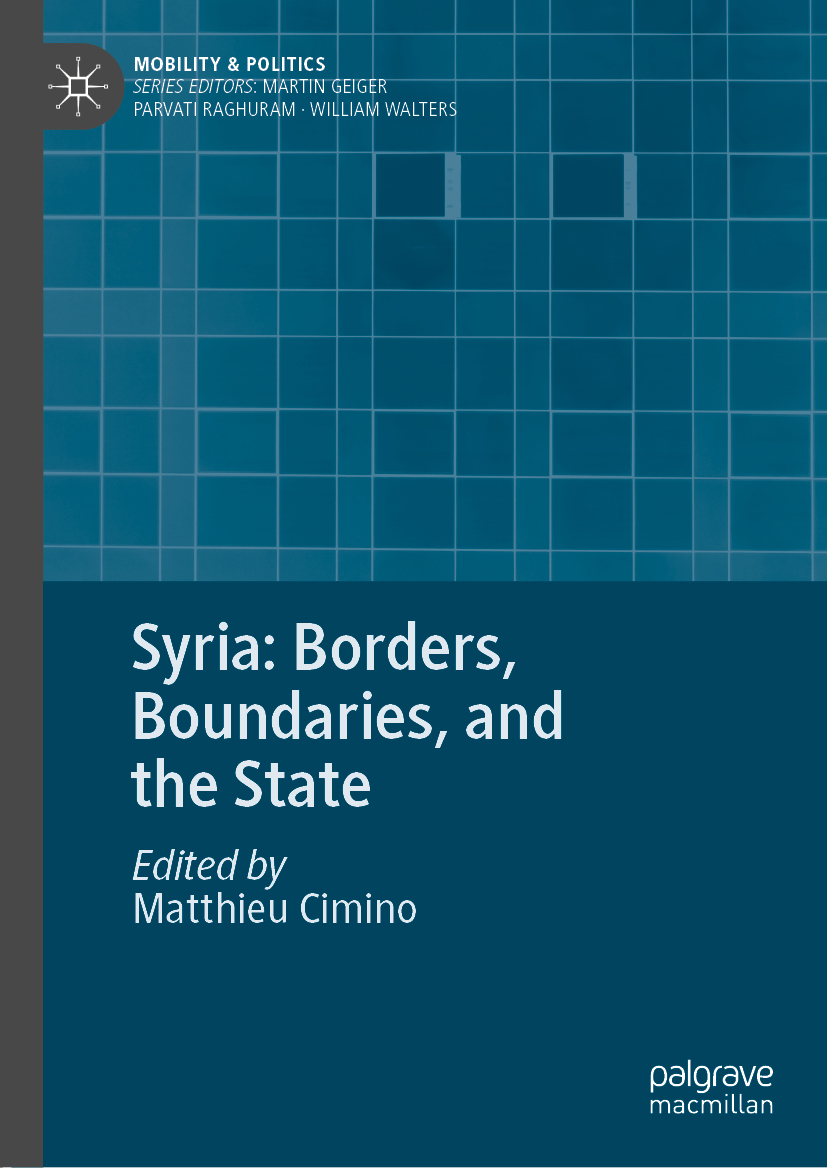
Syria This book explores the history of Syria’s borders and boundaries, from their creation (1920) until the civil war (2011) and their contestation by the Islamic State or the Kurdish movement. The volume’s main objective is to reconsider the “artificial†character of the Syrian territory and to reveal the processes by which its borders were shaped and eventually internalized by the country’s main actors. Based on extensive archival research, the book first documents the creation and stabilization of Syrian borders before and during the mandates period (nineteenth century to 1946), studying Ottoman and French territorialization strategies but also emphasizing the key role of the borderlands in this process. In turn, it investigates the perceptual boundaries resulting from the conflict, and how they materialized in space. Lastly, it explores the geographical and political imaginaries of non-state actors (PYD, ISIS) that emerged from the war. POLITICAL SCIENCE,International Relations,General
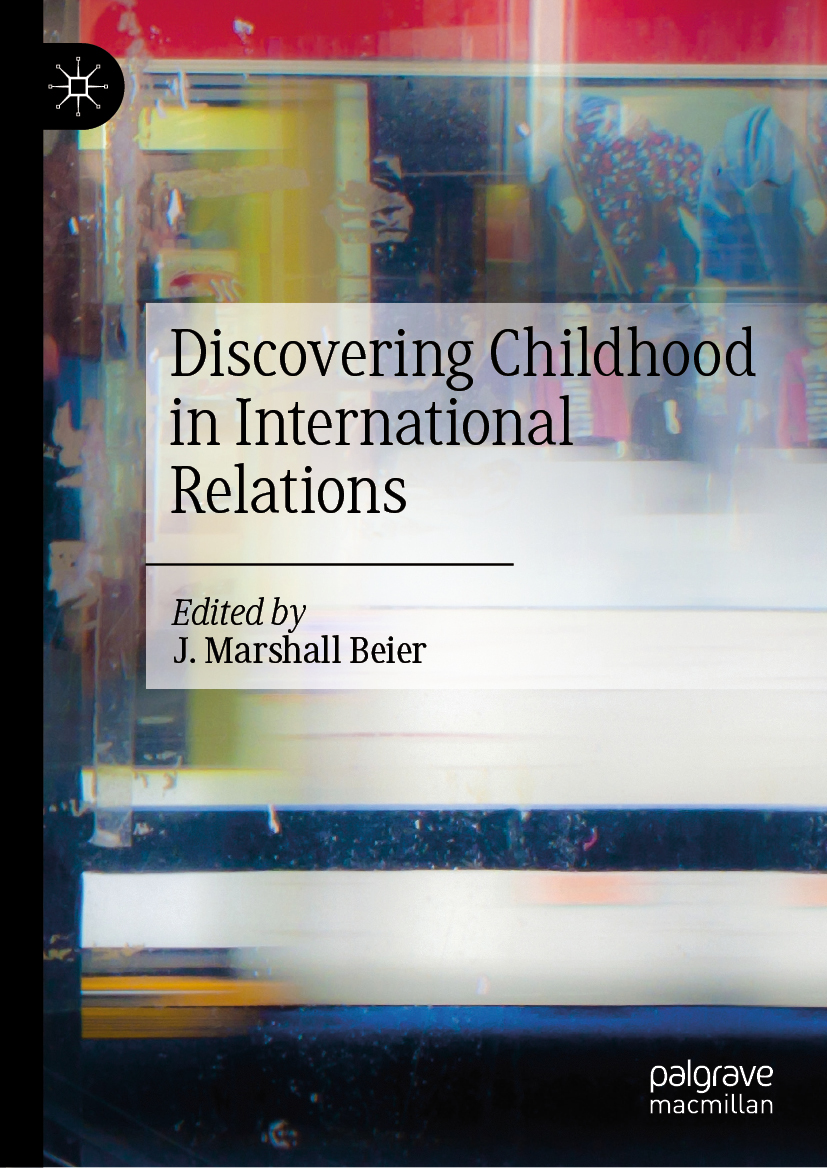
Discovering Childhood in International Relations This book examines how and why, in the context of International Relations, children’s subjecthood has all too often been relegated to marginal terrains and children themselves automatically associated with the need for protection in vulnerable situations: as child soldiers, refugees, and conflated with women, all typically with the accent on the Global South. Challenging us to think critically about childhood as a technology of global governance, the authors explore alternative ways of finding children and their agency in a more central position in IR, in terms of various forms of children’s activism, children and climate change, children and security, children and resilience, and in their inevitable role in governing the future. Focusing on the problems, pitfalls, promises, and prospects of addressing children and childhoods in International Relations, this book places children more squarely in the purview of political subjecthood and hence more centrally in IR. POLITICAL SCIENCE,International Relations,General
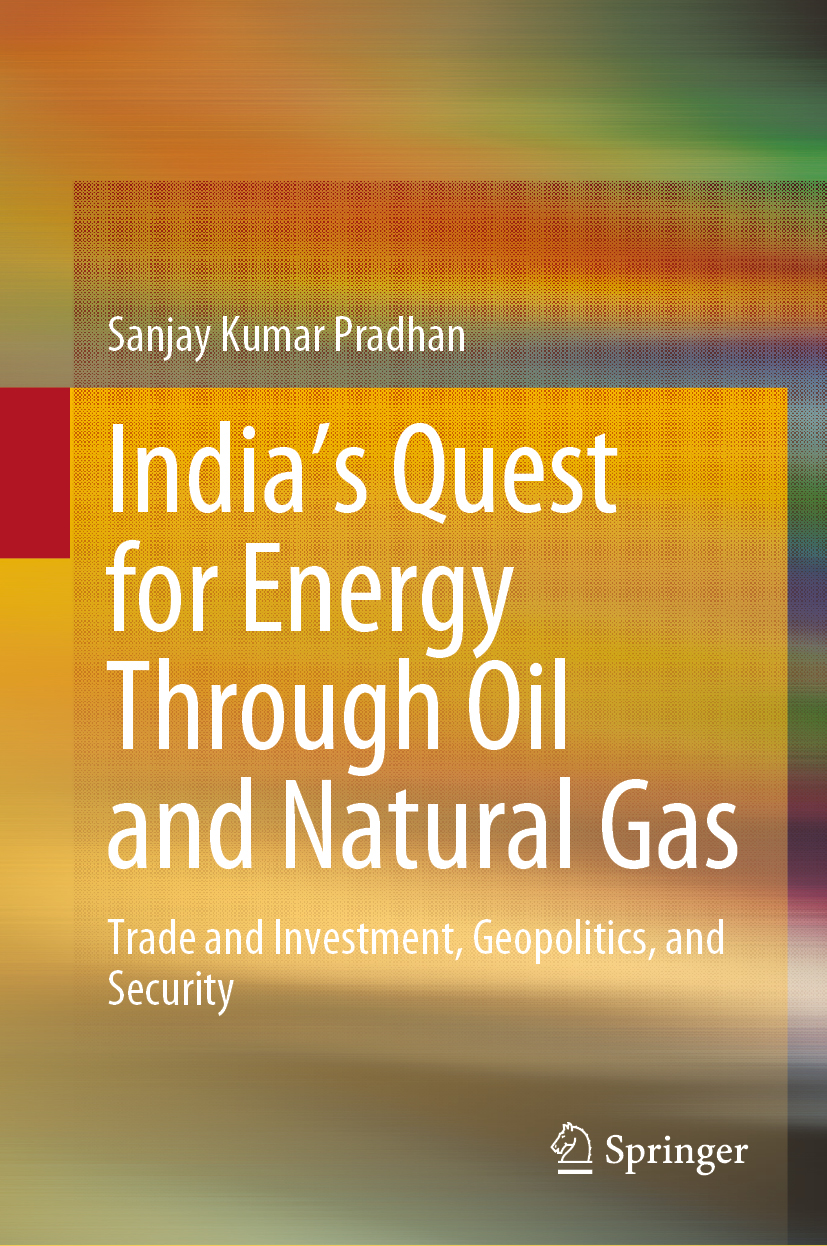
India’s Quest for Energy Through Oil and Natural Gas This book analyzes energy security through the lens of oil and natural gas and explains how geopolitics and security challenges affect India’s quest for energy security. It also offers insights into India’s international trade and investment in the overseas oil and natural gas markets and discusses shale energy, adopting region-specific (Africa, West Asia, Central Asia, and LAC), country-specific (Russia and the US), maritime-specific (Arctic and South China Sea), and pipeline-specific (TAPI, MBI, IPI, and RCI) approaches to analyze India’s oil and natural gas trade and investment abroad. The introductory chapter examines energy perspectives in international relations and conceptualizes energy geopolitics and energy security from both international and Indian standpoints. The book also highlights the similarities and differences in the issues involved in the global oil and natural gas market, and India’s approach to these, offering a roadmap for holistic and integrated energy security through oil and natural gas. Since India’s energy trade and investment in the international oil and natural gas market are not free from the effects of political instability, corruption, environment crisis, militancy, terrorism, war, and geopolitical involvement and interference, the book investigates the nature and extent of the security threats and competition India faces in the oil and natural gas-producing countries while pursuing its trade and investments there. As major sources of energy, oil and natural gas are strategic assets, and energy security is one of the core areas of India’s foreign policy pursuits. As such, the chapters critically assess India’s energy policy and resource diplomacy, providing analyses of the issues raised, identifying the central arguments and presenting existing cooperations – with past examples where necessary. The book appeals to scholars and policymakers active in the fields of energy, political science, international relations, economics, foreign policy, peace and conflict, security and geopolitics, as well as non-experts interested in this topic. POLITICAL SCIENCE,International Relations,General

Institutionalised Dreams Using examples from Poland, Elżbieta Drążkiewicz explores the question of why states become donors and individuals decide to share their wealth with others through foreign aid. She comes to the conclusion that the concept of foreign aid requires the establishment of a specific moral economy which links national ideologies and local cultures of charitable giving with broader ideas about the global political economy. It is through these processes that faith in foreign aid interventions as a solution to global issues is generated. The book also explores the relationship linking a state institution with its NGO partners, as well as international players such as the EU or OECD. POLITICAL SCIENCE,International Relations,General

Gender, Sexuality, and Intelligence Studies This is the first work to engage with intelligence studies through the lens of queer theory. Adding to the literature in critical intelligence studies and critical international relations theory, this work considers the ways in which both the spy, and the activities of espionage can be viewed as queer. Part One argues that the spy plays a role which represents a third path between the hard power of the military and the soft power of diplomacy. Part Two shows how the intelligence community plays a key role in enabling leaders of democracies to conduct covert activities running counter to that mission and ideology, in this way allowing a leader to have two foreign policies—an overt, public policy and a second, closeted, queer foreign policy. POLITICAL SCIENCE,International Relations,General

Entangling Relations Throughout what publisher Henry Luce dubbed the "American century," the United States has wrestled with two central questions. Should it pursue its security unilaterally or in cooperation with others? If the latter, how can its interests be best protected against opportunism by untrustworthy partners? In a major attempt to explain security relations from an institutionalist approach, David A. Lake shows how the answers to these questions have differed after World War I, during the Cold War, and today. In the debate over whether to join the League of Nations, the United States reaffirmed its historic policy of unilateralism. After World War II, however, it broke decisively with tradition and embraced a new policy of cooperation with partners in Europe and Asia. Today, the United States is pursuing a new strategy of cooperation, forming ad hoc coalitions and evincing an unprecedented willingness to shape but then work within the prevailing international consensus on the appropriate goals and means of foreign policy. In interpreting these three defining moments of American foreign policy, Lake draws on theories of relational contracting and poses a general theory of security relationships. He arrays the variety of possible security relationships on a continuum from anarchy to hierarchy, and explains actual relations as a function of three key variables: the benefits from pooling security resources and efforts with others, the expected costs of opportunistic behavior by partners, and governance costs. Lake systematically applies this theory to each of the "defining moments" of twentieth-century American foreign policy and develops its broader implications for the study of international relations. POLITICAL SCIENCE,International Relations,General

Turkey’s Mission Impossible Providing a unique record of the authoritarian, centralist and ultra-nationalist nature of the Turkish state manifested in Erdoğan's “New Turkey," Çandar challenges stereotyped and conventional views on Turkey and details account of the encounter between Turkey and the Kurds in historical perspective with special emphasis on failed peace processes. POLITICAL SCIENCE,International Relations,General
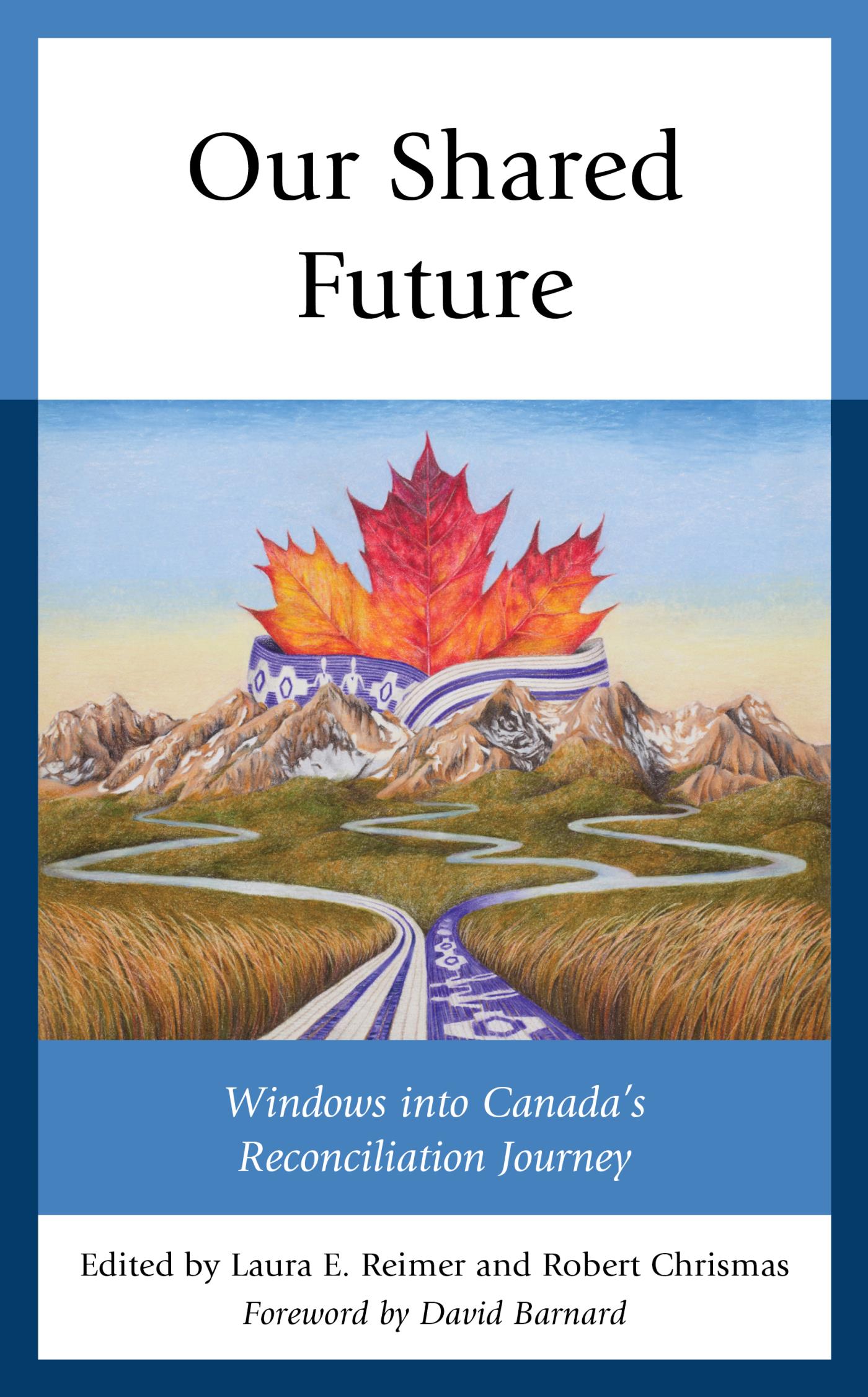
Our Shared Future This collection provides windows into Canada’s conflicted history and the innovative and courageous efforts to reconcile relationships between Indigenous people and settler descendants. The vision and deep experience of scholars and leaders from across the country offer tangible ways that Canada is working toward a peaceful shared future. POLITICAL SCIENCE,International Relations,General
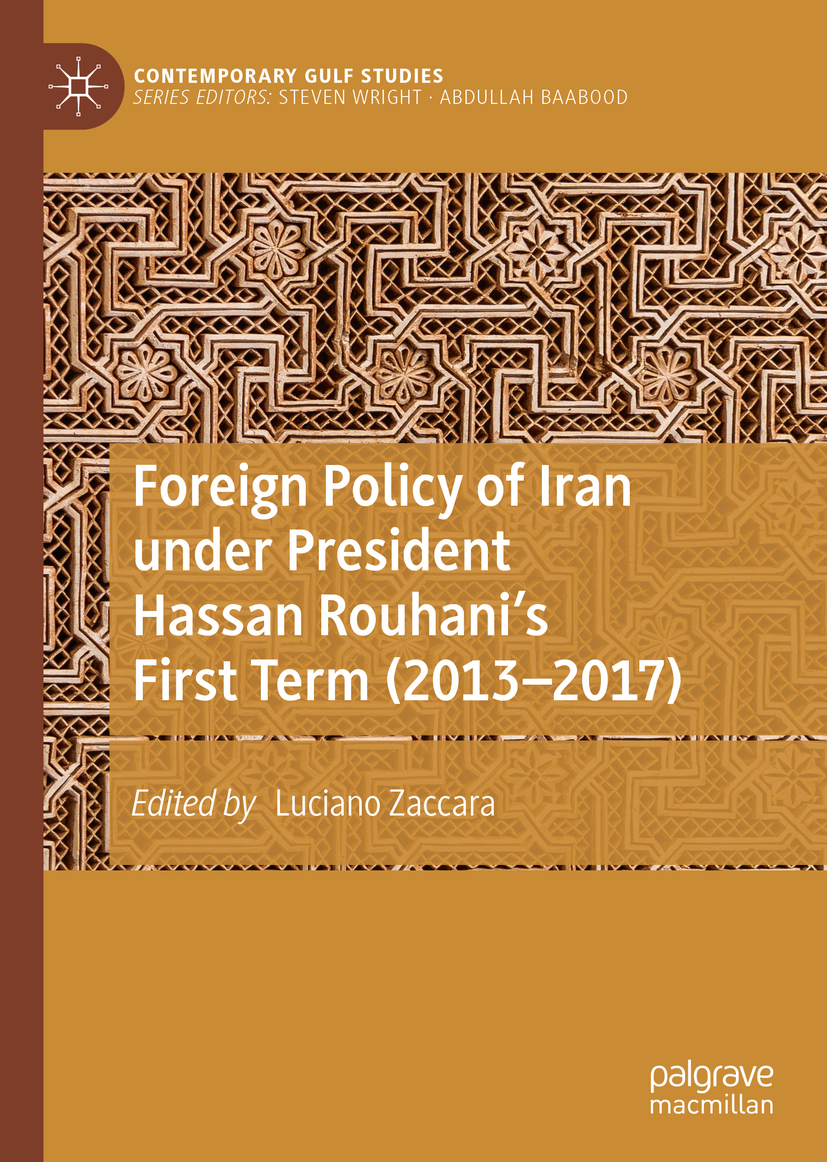
Foreign Policy of Iran under President Hassan Rouhani's First Term (2013–2017) The book deals with President Hassan Rouhani’s conceptual approach to foreign policy. It discusses the main pillars of thinking underpinning Rouhani’s administration and the school of thought associated with it, with a focus on issues pertaining to development as well as international relations. The signature of the “Joint Comprehensive Plan of Action†in 2015 showed the Iranian commitment towards the international requests on guarantees and transparency on its nuclear enrichment program. The book analyses the actual impact of the nuclear deal on the Gulf regional politics, with especial emphasis on the Iran-Saudi Arabia balance of power and the internal implications at political and economic level. It will assess the success or failure of the nuclear deal JCPOA as a foreign policy tool and it impact for Iran and the region. The book also analyses Iran’s relations with other gulf Arab states, Latin America, Africa and its ‘war on terror’ along with its allies Syria and Iraq. POLITICAL SCIENCE,International Relations,General
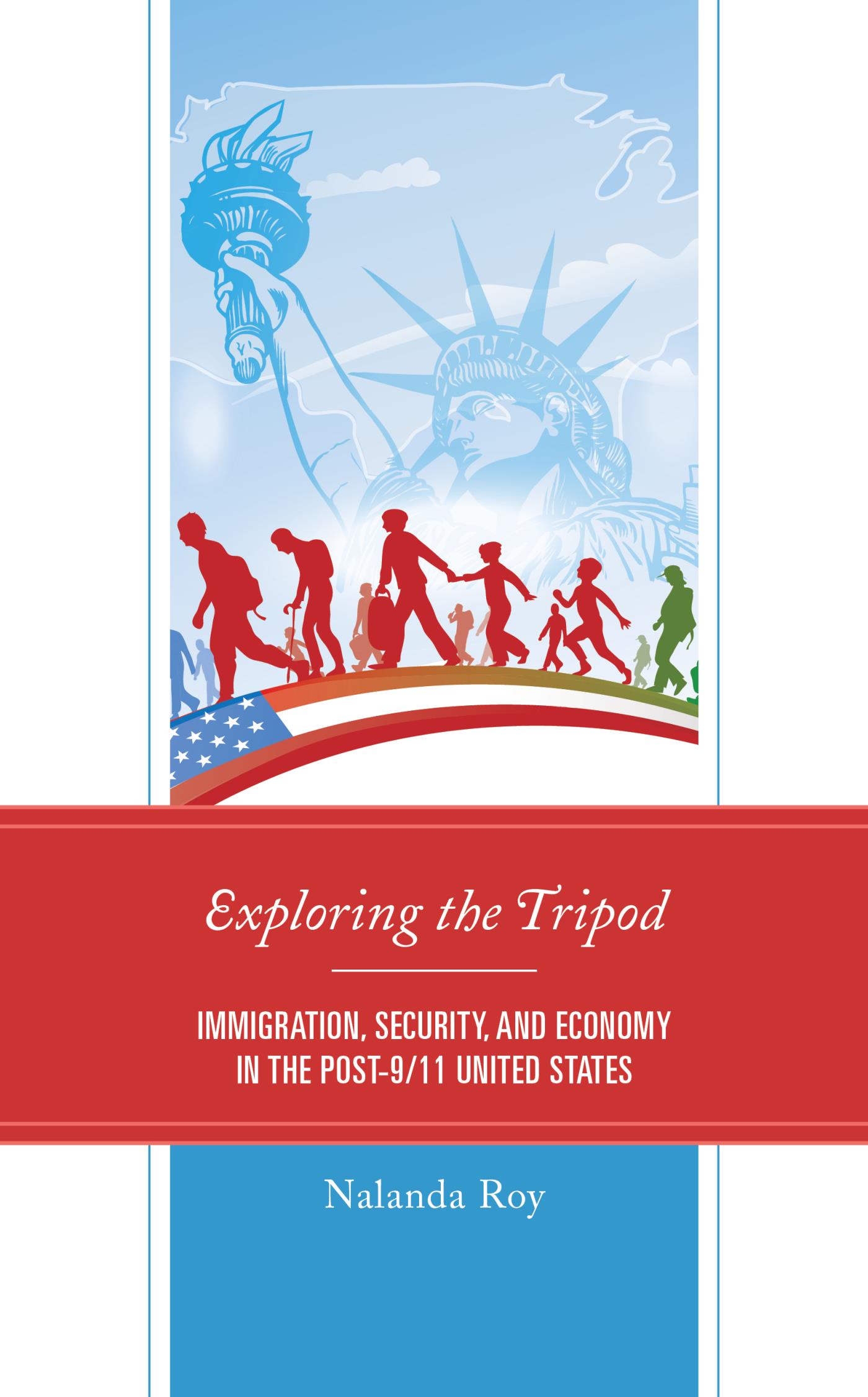
Exploring the Tripod Global terrorism has emerged as a central security issue throughout the world, and effective immigration and border control is now a necessary condition to maintain national security. This book identifies the security-related implications and determinants of immigration and border policies in the United States. POLITICAL SCIENCE,International Relations,General
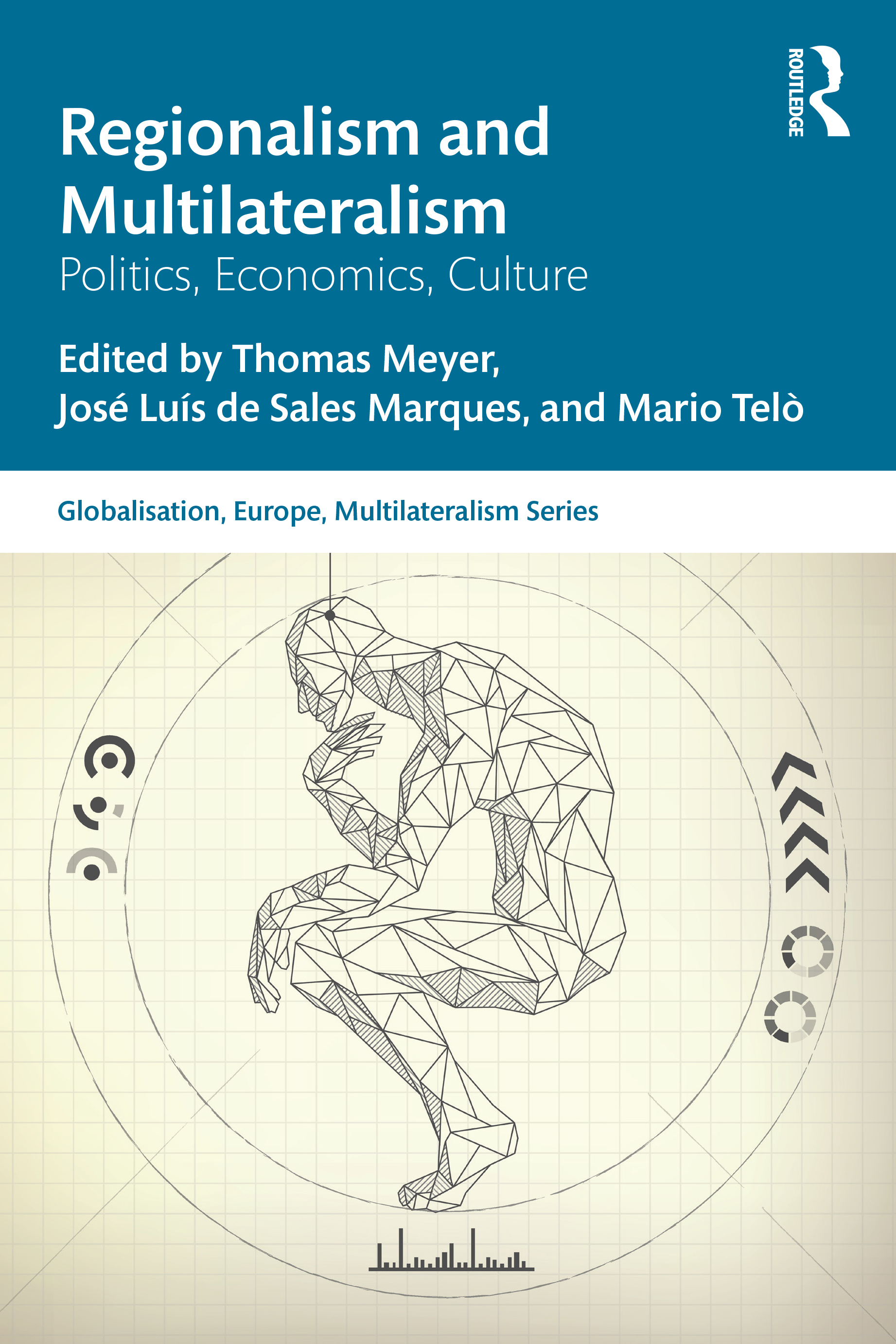
Regionalism and Multilateralism This book discusses the impact of cultural diversities and identities on regional and interregional cooperation, as well as on multilateralism. Employing a comparative approach to organizations such as ASEAN, MERCOSUR, SAARC, and the African and European Unions, this volume seeks to understand their distinctive features and patterns of interaction. It also explores the diffusion of multidimensional interregional relations, including but not limited to the field of trade. Scholars from several disciplines and four continents offer insights concerning the consequences of both multiple modernities and the rise of authoritarian populism for regionalism, interregionalism, and multilateralism. The Covid-19 pandemic confirmed the decline of hegemonic multilateralism. Among alternative possible scenarios for global governance, the "new multilateralism" receives special attention. This book will be of key interest to European/EU studies, economics, history, cultural studies, international relations, international political economy, security studies, and international law. POLITICAL SCIENCE,International Relations,General

The Road to Democracy in Iran A famous Iranian dissident calls for universal human rights and democracy based on our common humanity. Akbar Ganji, called by some “Iran's most famous dissident,” was a member of the Islamic Revolutionary Guard Corps. But, troubled by the regime's repressive nature, he became an investigative journalist in the 1990s, writing for Iran's pro-democracy newspapers. Most notably, he traced the murders of dissident intellectuals to Iran's secret service. In 2000, Ganji was arrested, sentenced to six years in prison, and banned from working as a journalist. His eighty-day hunger strike during his last year in prison mobilized the international human rights community.The Road to Democracy in Iran, Ganji's first book in English, demonstrates his lifelong commitment to human rights and democracy. A passionate call for universal human rights and the right to democracy from a Muslim perspective, it lays out the goals and means of Iran's democracy movement, why women's rights trump some interpretations of Islamic law, and how the West can help promote democracy in Iran (he strongly opposes U.S. intervention) and other Islamic countries. Throughout the book Ganji argues consistently for universal rights based on our common humanity (and he believes the world's religions support that idea). But his arguments never veer into abstraction; they are rooted deeply in the realities of life in Islamic countries, and offer a clear picture of the possibilities for and obstacles to improving human rights and promoting democracy in the Muslim world. Since his release from prison in March 2006, Akbar Ganji has been traveling outside Iran, meeting with intellectuals and activists in the international human rights community. He is currently living in the United States. POLITICAL SCIENCE,International Relations,General

International Relations in the Cyber Age A foundational analysis of the co-evolution of the internet and international relations, examining resultant challenges for individuals, organizations, firms, and states. In our increasingly digital world, data flows define the international landscape as much as the flow of materials and people. How is cyberspace shaping international relations, and how are international relations shaping cyberspace? In this book, Nazli Choucri and David D. Clark offer a foundational analysis of the co-evolution of cyberspace (with the internet as its core) and international relations, examining resultant challenges for individuals, organizations, and states. The authors examine the pervasiveness of power and politics in the digital realm, finding that the internet is evolving much faster than the tools for regulating it. This creates a “co-evolution dilemma”—a new reality in which digital interactions have enabled weaker actors to influence or threaten stronger actors, including the traditional state powers. Choucri and Clark develop a new method for addressing control in the internet age, “control point analysis,” and apply it to a variety of situations, including major actors in the international and digital realms: the United States, China, and Google. In doing so they lay the groundwork for a new international relations theory that reflects the reality in which we live—one in which the international and digital realms are inextricably linked and evolving together. POLITICAL SCIENCE,International Relations,General

Winning Together Strategies for transboundary natural resource management; winner of Harvard Law School's Raiffa Award for best research of the year in negotiation and conflict resolution. Transboundary natural resource negotiations, often conducted in an atmosphere of entrenched mistrust, confrontation, and deadlock, can go on for decades. In this book, Bruno Verdini outlines an approach by which government, private sector, and nongovernmental stakeholders can overcome grievances, break the status quo, trade across differences, and create mutual gains in high-stakes water, energy, and environmental negotiations. Verdini examines two landmark negotiations between the United States and Mexico. The two cases—one involving conflict over shared hydrocarbon reservoirs in the Gulf of Mexico and the other involving disputes over the shared waters of the Colorado River—resulted in groundbreaking agreements in 2012, after decades of deadlock. Drawing on his extensive interviews with more than seventy high-ranking negotiators in the United States and Mexico—from presidents and ambassadors to general managers, technical experts, and nongovernmental advocates—Verdini offers detailed accounts from multiple points of view, on both sides of the border. He unpacks the negotiation, leadership, collaborative decision-making, and political communication strategies that made agreement possible. Building upon the theoretical and empirical findings, Verdini offers advice for practitioners on effective negotiation and dispute resolution strategies that avoid the presumption that there are not enough resources to go around, and that one side must win and the other must inevitably lose. This investigation is the winner of Harvard Law School's Howard Raiffa Award for best research of the year in negotiation, mediation, decision-making, and dispute resolution. POLITICAL SCIENCE,International Relations,General
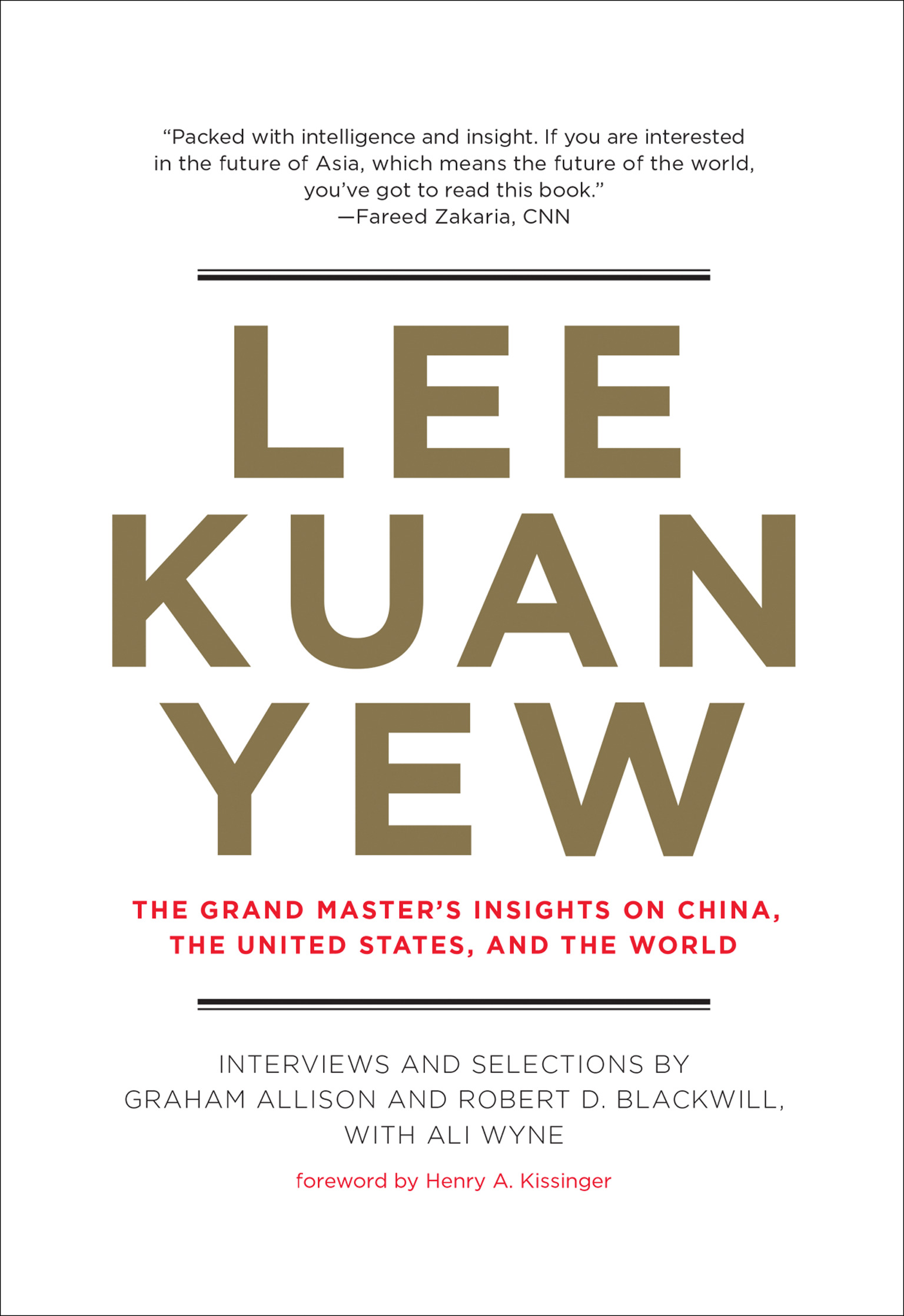
Lee Kuan Yew Grand strategist and founder of modern Singapore offers key insights and controversial opinions on globalization, geopolitics, economic growth, and democracy. When Lee Kuan Yew speaks, presidents, prime ministers, diplomats, and CEOs listen. Lee, the founding father of modern Singapore and its prime minister from 1959 to 1990, has honed his wisdom during more than fifty years on the world stage. Almost single-handedly responsible for transforming Singapore into a Western-style economic success, he offers a unique perspective on the geopolitics of East and West. American presidents from Richard Nixon to Barack Obama have welcomed him to the White House; British prime ministers from Margaret Thatcher to Tony Blair have recognized his wisdom; and business leaders from Rupert Murdoch to Rex Tillerson, CEO of Exxon Mobil, have praised his accomplishments. This book gathers key insights from interviews, speeches, and Lee's voluminous published writings and presents them in an engaging question and answer format. Lee offers his assessment of China's future, asserting, among other things, that “China will want to share this century as co-equals with the U.S.” He affirms the United States' position as the world's sole superpower but expresses dismay at the vagaries of its political system. He offers strategic advice for dealing with China and goes on to discuss India's future, Islamic terrorism, economic growth, geopolitics and globalization, and democracy. Lee does not pull his punches, offering his unvarnished opinions on multiculturalism, the welfare state, education, and the free market. This little book belongs on the reading list of every world leader—including the one who takes the oath of office on January 20, 2013. POLITICAL SCIENCE,International Relations,General

The Soul of Iran The truths about Iran; quite different truths from versions put forward by Washington, Tehran, and the media. Iran thundered onto the world stage in 1979 with an Islamic revolution that shook the world. Today that revolution has gone astray, a popular democracy movement boldly challenges authority, and young Iranians are more interested in moving to America than in chanting "Death to America." Afshin Molavi, born in Iran and fluent in Persian, traveled widely across his homeland, exploring the legacy of the Iranian revolution and probing the soul of Iran, a land with nearly three millennia of often-glorious history. Like a master Persian carpet maker, Molavi weaves together threads of rich historical insight, political analysis, cultural observation, and the daily realities of life in the Islamic republic to produce a colorful, intricate, and mesmerizing narrative. Originally published in hardcover under the title Persian Pilgrimages, this paperback edition is revised, with a new introduction and epilogue. POLITICAL SCIENCE,International Relations,General
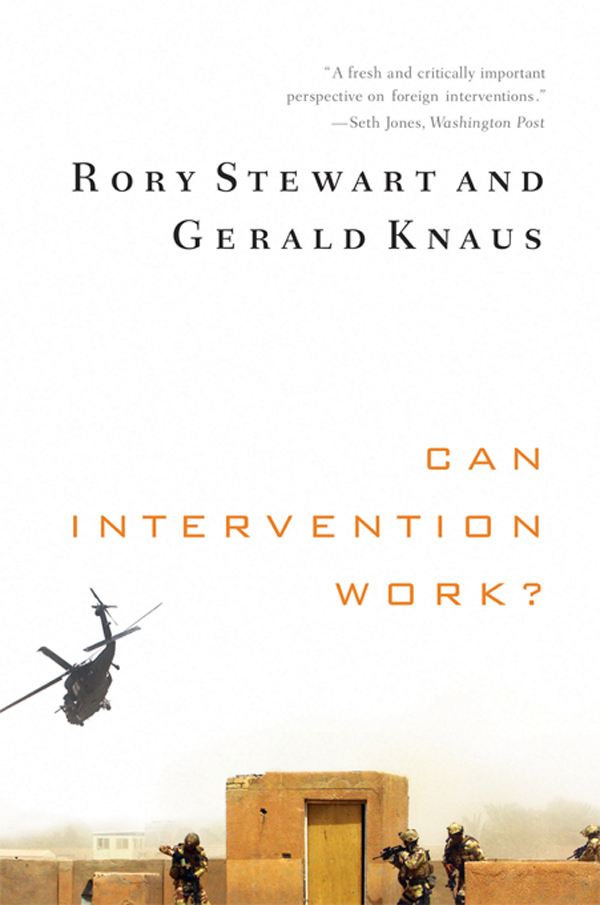
Can Intervention Work? (Norton Global Ethics Series) Best-selling author Rory Stewart and political economist Gerald Knaus examine the impact of large-scale interventions, from Bosnia to Afghanistan. “A fresh and critically important perspective on foreign interventions†(Washington Post), Can Intervention Work? distills Rory Stewart’s (author of The Places In Between) and Gerald Knaus’s remarkable firsthand experiences of political and military interventions into a potent examination of what we can and cannot achieve in a new era of nation building. As they delve into the massive, military-driven efforts in Bosnia, Iraq, and Afghanistan, the authors reveal each effort’s enormous consequences for international relations, human rights, and our understanding of state building. Stewart and Knaus parse carefully the philosophies that have informed interventionism—from neoconservative to liberal imperialist—and draw on their diverse experiences in the military, nongovernmental organizations, and the Iraqi provincial government to reveal what we can ultimately expect from large-scale interventions and how they might best realize positive change in the world. Author and columnist Fred Kaplan calls Can Intervention Work? “the most thorough examination of the subject [of intervention] that I’ve read in a while.†POLITICAL SCIENCE,International Relations,General
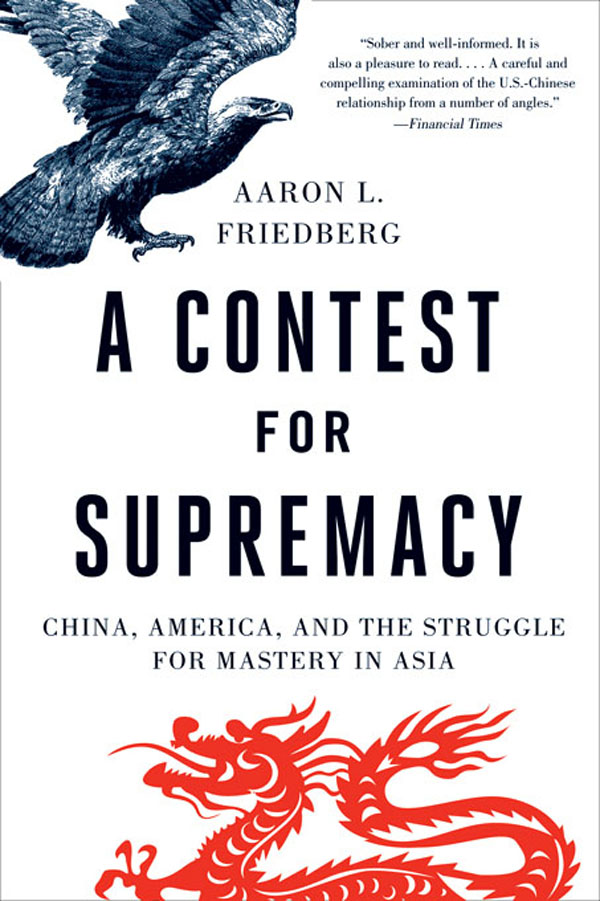
A Contest for Supremacy “Sober and well-informed. . . . A careful and compelling examination of the U.S.-Chinese relationship from a number of angles.â€â€”Financial Times There may be no denying China's growing economic strength, but its impact on the global balance of power remains hotly contested. Political scientist Aaron L. Friedberg argues that our nation's leaders are failing to act expeditiously enough to counter China's growing strength. He explains how the United States and China define their goals and reveals the strategies each is now employing to achieve its ends. Friedberg demonstrates in this provocative book that the ultimate aim of Chinese policymakers is to "win without fighting," displacing the United States as the leading power in Asia while avoiding direct confrontation. The United States, on the other hand, sends misleading signals about our commitments and resolve, putting us at risk for a war that might otherwise have been avoided. A much-needed wake-up call to U.S. leaders and policymakers, A Contest for Supremacy is a compelling interpretation of a rivalry that will go far to determine the shape of the twenty-first century. POLITICAL SCIENCE,International Relations,General
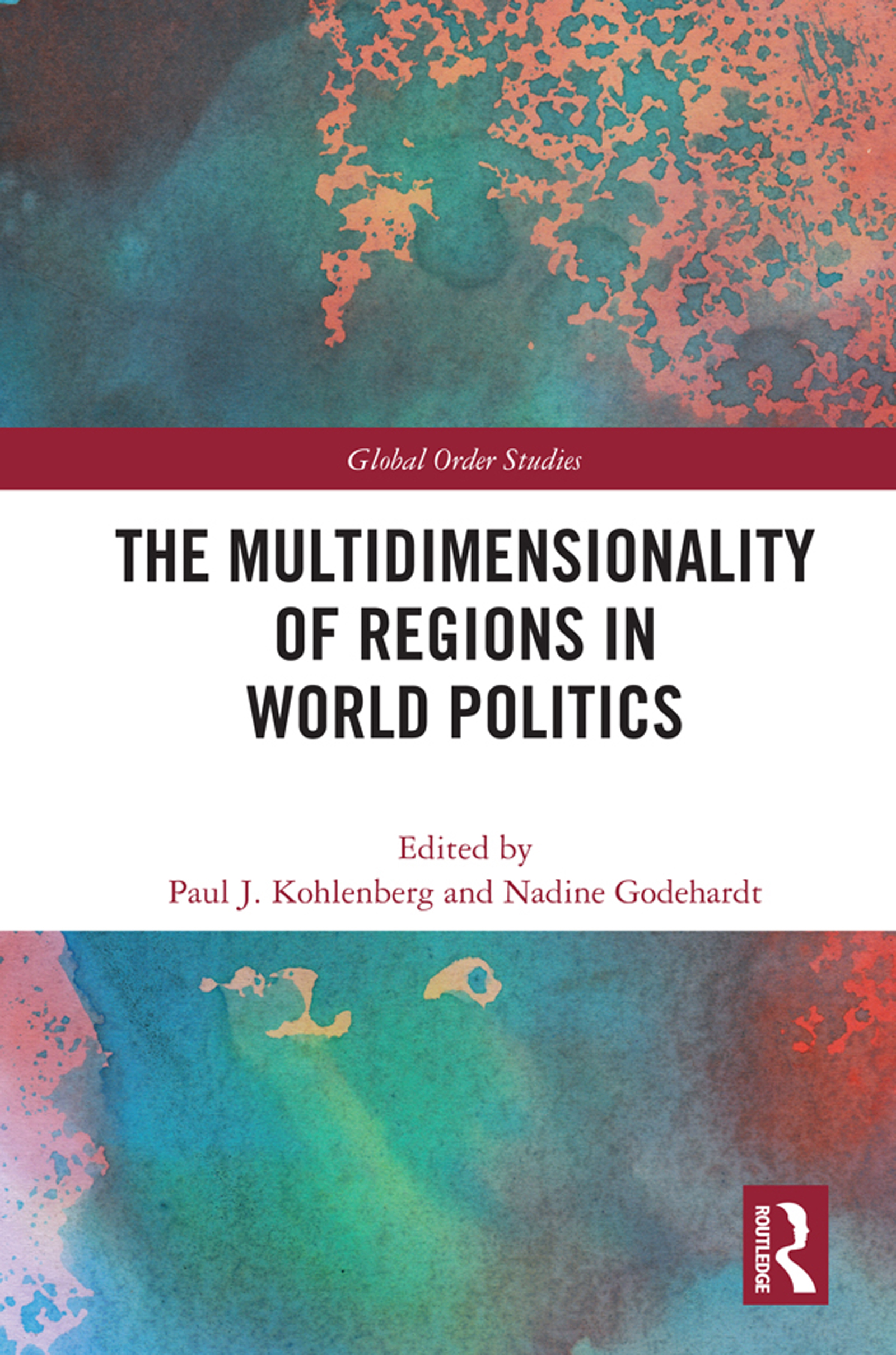
The Multidimensionality of Regions in World Politics This book examines what counts regarding the role and conceptualization of regions in world politics. It presents a fresh look at which narratives awake, persist, fall dormant or re-emerge amidst diverse interlocking processes of environmental, technological and global political changes. It puts forward a thorough and multidimensional conceptualization of regions as embedded in changing, overlapping environments, and requires more attention to regions’ shifting materiality, temporality and technological underpinnings. Combing the approaches, questions and analyses of Critical IR and Political Geography, it calls for a renewed emphasis on the puzzle of how the contextual environment of regions may become more (or less) multidimensional, or how some aspects of a region’s contextual environment may be mutually constitutive in non-intuitive ways. Ultimately, it sheds light on the politics of regions and the regional scale in international politics in order to overcome the often-underlying territorial fixity of territory and space within IR approaches. This book will be of key interest to scholars and students of international relations, international political sociology, political geography, regionalism, geopolitics and area studies. POLITICAL SCIENCE,International Relations,General
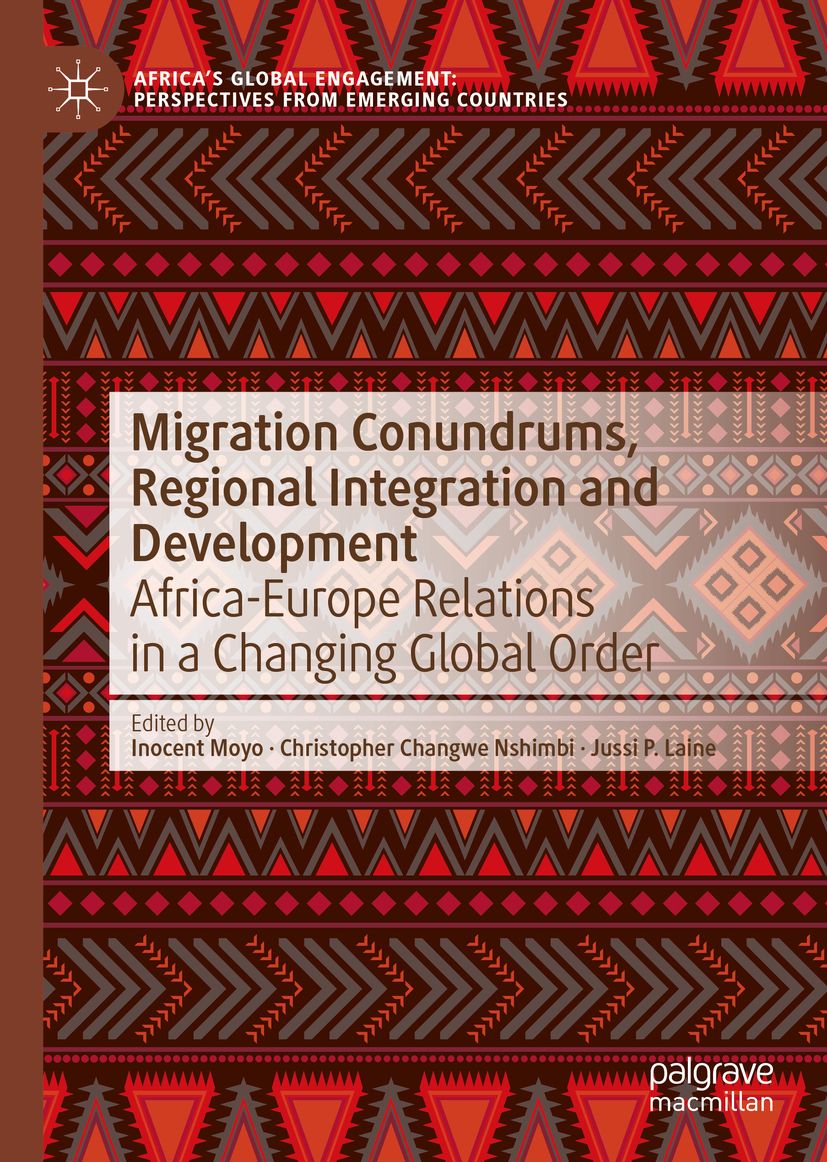
Migration Conundrums, Regional Integration and Development This book examines Africa-Europe relationships and intra-Africa relationships vis-à -vis migration. It analyses the African integration project that is being used to effectively manage migration within Africa and across its RECs, and harnessing it for development. The book presents debates related to the EU’s hardening and securitisation of its external border against migrants from Africa. It shows that migration actually challenges Africa-European relations, which is discussed as an important theme in this book. Authors in this book volume investigate several issues ranging from conundrums relating to migration between Africa and Europe to migration within Africa, but also in relation to borders and boundaries, its bearing on regional and continental integration and the significance of this in terms of relations between Africa and Europe. This book volume brings into conversation issues relating to the governance of migration for development, social cohesion and regional integration. POLITICAL SCIENCE,International Relations,General
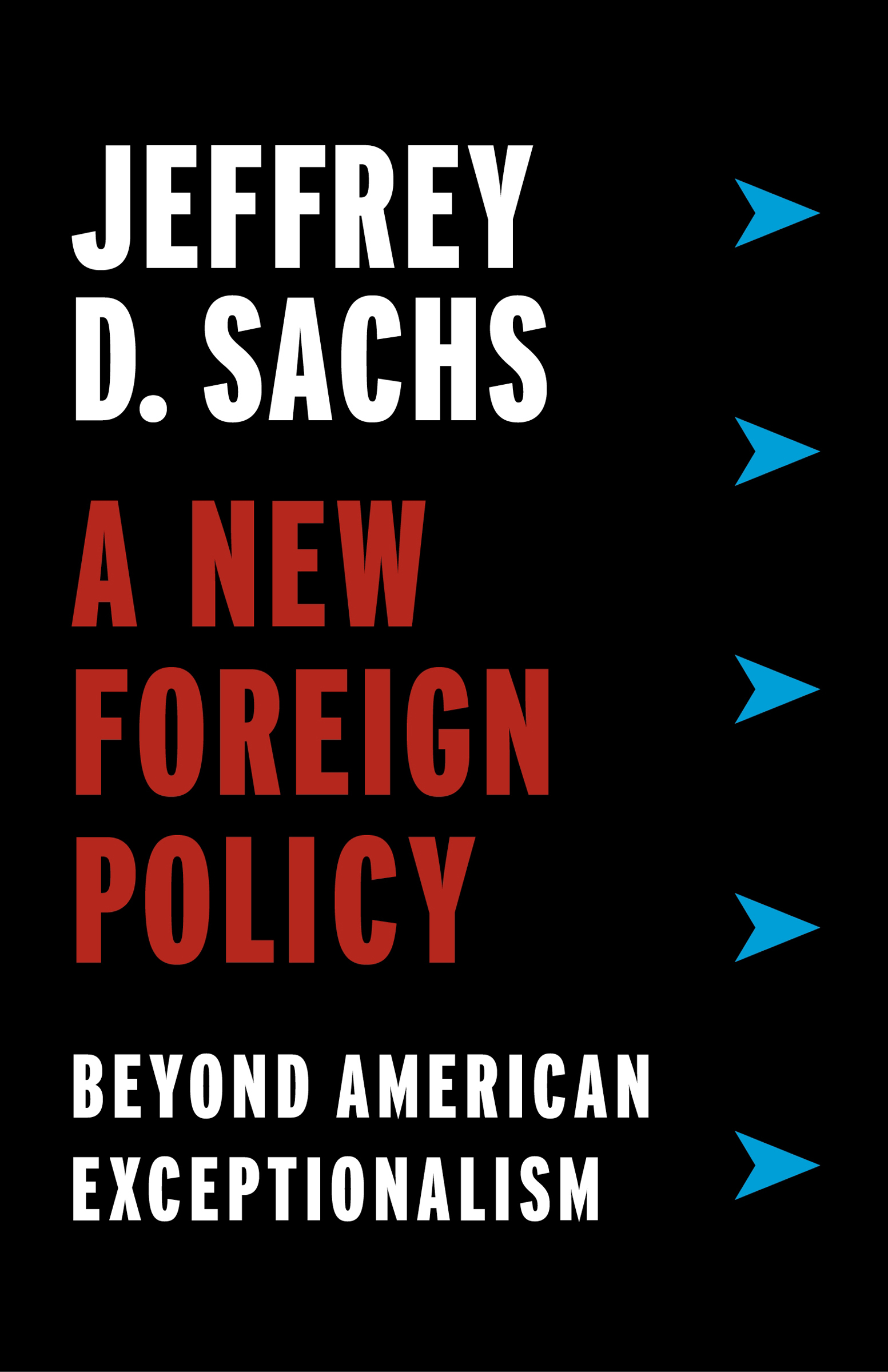
A New Foreign Policy In this sobering analysis of American foreign policy under Trump, the award-winning economist calls for a new approach to international engagement. The American Century began in 1941 and ended in 2017, on the day of President Trump’s inauguration. The subsequent turn toward nationalism and “America first†unilateralism did not made America great. It announced the abdication of our responsibilities in the face of environmental crises, political upheaval, mass migration, and other global challenges. As a result, America no longer dominates geopolitics or the world economy as it once did. In this incisive and passionate book, Jeffrey D. Sachs provides the blueprint for a new foreign policy that embraces global cooperation, international law, and aspirations for worldwide prosperity. He argues that America’s approach to the world must shift from military might and wars of choice to a commitment to shared objectives of sustainable development. A New Foreign Policy explores both the danger of the “America first†mindset and the possibilities for a new way forward, proposing timely and achievable plans to foster global economic growth, reconfigure the United Nations for the twenty-first century, and build a multipolar world that is prosperous, peaceful, fair, and resilient. POLITICAL SCIENCE,International Relations,General
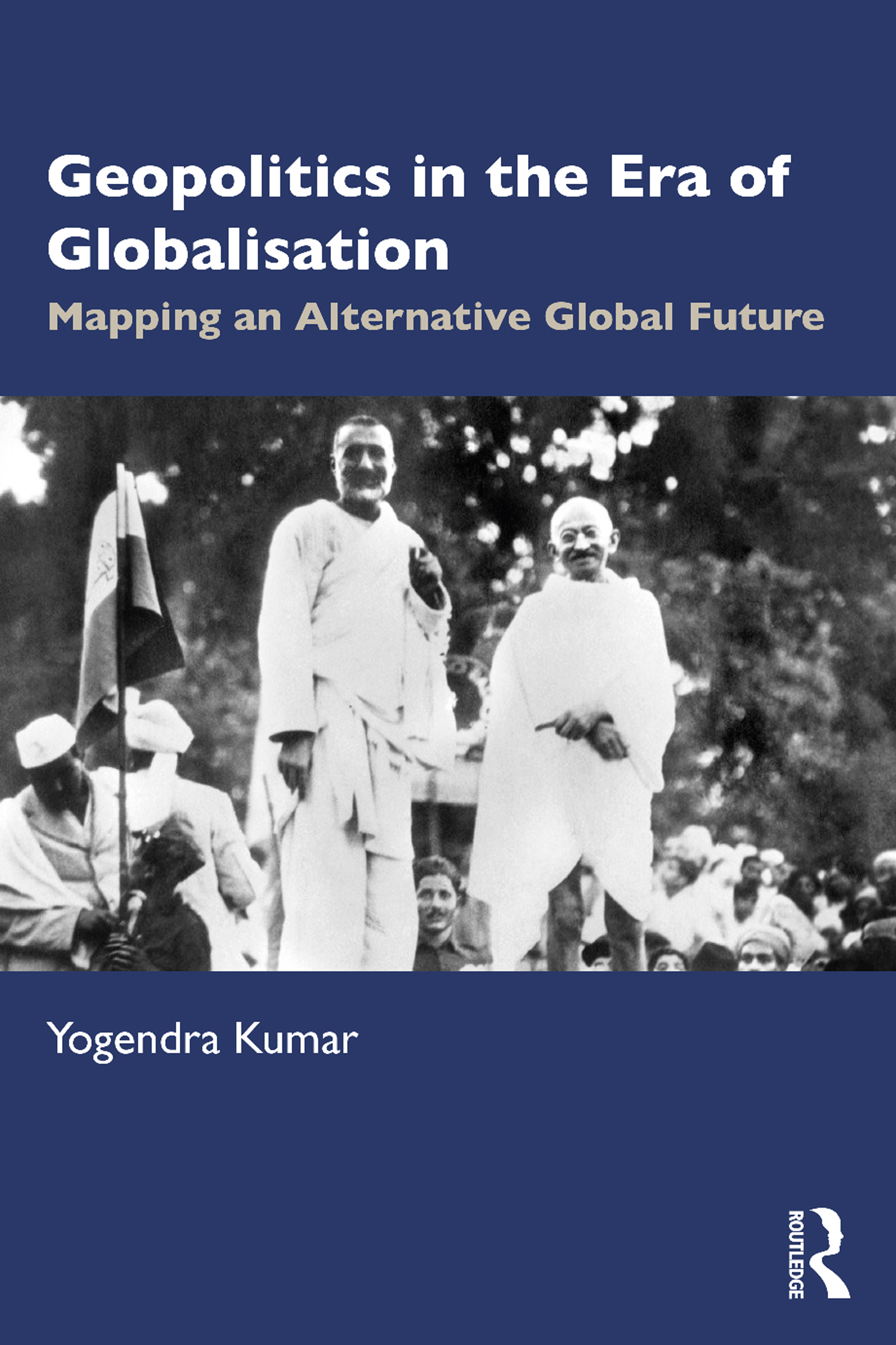
Geopolitics in the Era of Globalisation This book presents an alternative roadmap for a world characterised by geopolitical uncertainty. The surging expectations about a future world of democratic values and high economic growth, born out of superpower bonhomie at the end of the Cold War, did not lead to the promised outcomes. Instead we are faced with deeply destabilising challenges, like climate change, widespread state fragility, terrorism, arms race, disruptive newer technologies, global economic volatility, and ineffectiveness of multilateral institutions, old and new. The volume: surveys the intellectual discourse, the attempts to redesign the global institutions, and the geopolitical trends since the end of the Cold War for an understanding of the contemporary geopolitics, analyses the characteristics of the contemporary geopolitics, the seeming intractability of the global challenges, and the ongoing discourse about preventing their further deterioration, foregrounds the Gandhian praxis and IR theory for managing power transitions anchored in non-violent mobilisation of empowered masses, ensuring institutional resilience, and illustrates them through ongoing conflicts in Iraq and Afghanistan, outlines an approach, based on the Gandhian experience of managing political change, towards conflict, geopolitical uncertainties, and institutional ineffectiveness for securing a better future globally, including South Asia. Accessibly written, this volume will be indispensable for foreign policy experts, government think tanks, and career bureaucrats. It will also be essential for scholars and researchers of international relations, foreign policy, politics, and governance and public policy. POLITICAL SCIENCE,International Relations,General

Emergent Actors in World Politics The disappearance and formation of states and nations after the end of the Cold War have proved puzzling to both theorists and policymakers. Lars-Erik Cederman argues that this lack of conceptual preparation stems from two tendencies in conventional theorizing. First, the dominant focus on cohesive nation-states as the only actors of world politics obscures crucial differences between the state and the nation. Second, traditional theory usually treats these units as fixed. Cederman offers a fresh way of analyzing world politics: complex adaptive systems modeling. He provides a new series of models--not ones that rely on rational-choice, but rather computerized thought-experiments--that separate the state from the nation and incorporate these as emergent rather than preconceived actors. This theory of the emergent actor shifts attention away from the exclusively behavioral focus of conventional international relations theory toward a truly dynamic perspective that treats the actors of world politics as dependent rather than independent variables. Cederman illustrates that while structural realist predictions about unit-level invariance hold up under certain circumstances, they are heavily dependent on fierce power competition, which can result in unipolarity instead of the balance of power. He provides a thorough examination of the processes of nationalist mobilization and coordination in multi-ethnic states. Cederman states that such states' efforts to instill loyalty in their ethnically diverse populations may backfire, and that, moreover, if the revolutionary movement is culturally split, its identity becomes more inclusive as the power gap in the imperial center's favor increases. POLITICAL SCIENCE,International Relations,General

From 'Japan Problem' to 'China Threat'? This book has four main objectives: to bring the thus far almost entirely neglected historical case of ‘the rise of Japan’ into the literature on power shifts in general and ‘the rise of China’ in particular; to propose a discourse-based conceptualization of identity for the study of economic policy that engages theoretical and methodological debates on how to overcome the dichotomy between ‘ideational’ (identity) and ‘material’ (economic) factors; to address the tendency to focus on the ‘radical Other’ in poststructuralist IR scholarship, by highlighting how heterogeneity disturbs exclusive and binary articulations of identity and difference; and to propose a method for putting political discourse theory (PDT) into practice in empirical research by drawing on rhetorical political analysis (RPA). US congressional debates on economic policy on Japan and China in 1985–2008 are analysed as examples of official US elite public discourse. The book shows that the ‘new era’ in US-Chinese relations that scholars and policymakers have been announcing since the beginning of the Trump presidency was long in the making, as it rests on longstanding discourses on the USA’s main economic competitor. POLITICAL SCIENCE,International Relations,General
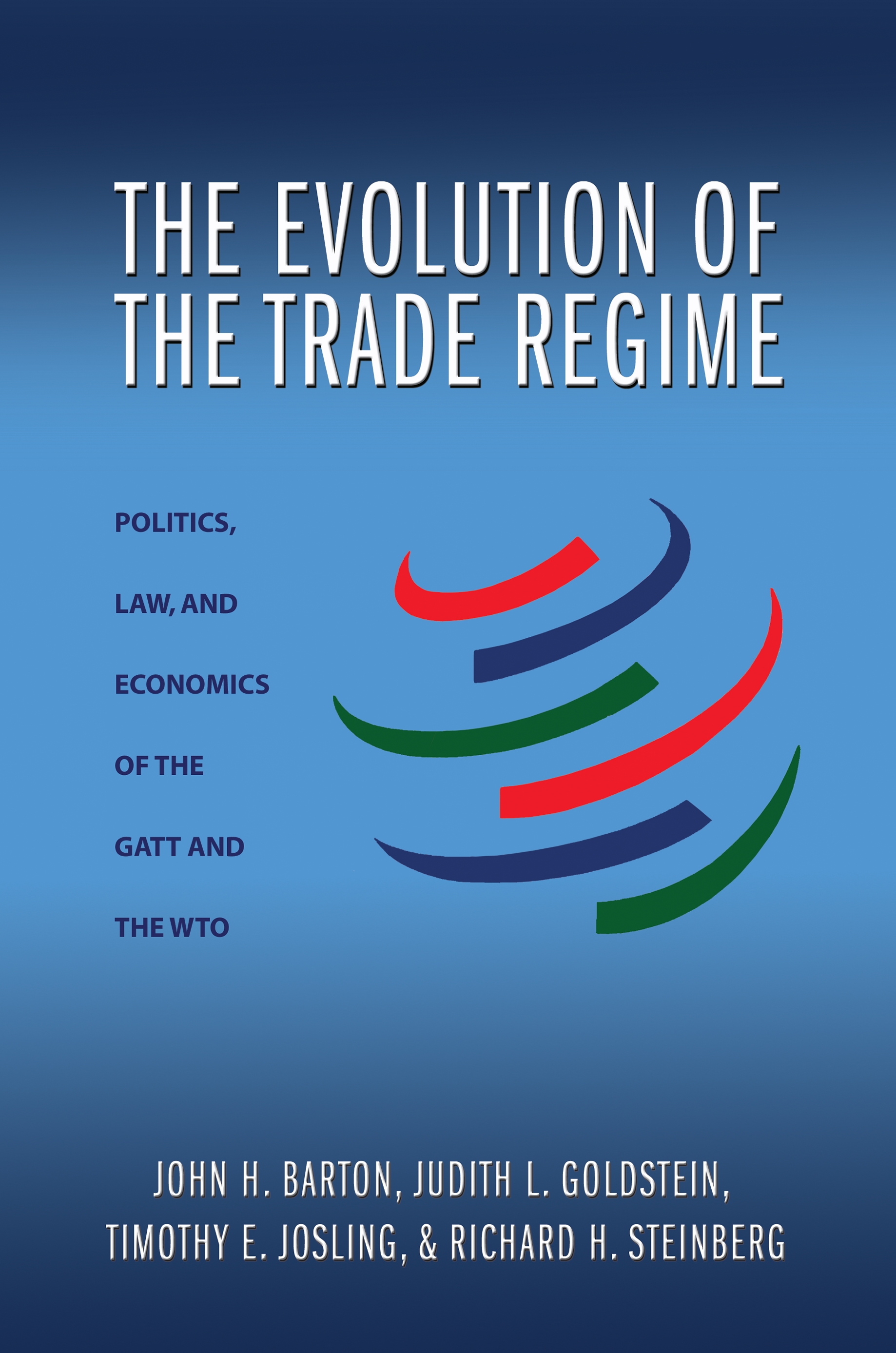
The Evolution of the Trade Regime The Evolution of the Trade Regime offers a comprehensive political-economic history of the development of the world's multilateral trade institutions, the General Agreement on Tariffs and Trade (GATT) and its successor, the World Trade Organization (WTO). While other books confine themselves to describing contemporary GATT/WTO legal rules or analyzing their economic logic, this is the first to explain the logic and development behind these rules. The book begins by examining the institutions' rules, principles, practices, and norms from their genesis in the early postwar period to the present. It evaluates the extent to which changes in these institutional attributes have helped maintain or rebuild domestic constituencies for open markets. The book considers these questions by looking at the political, legal, and economic foundations of the trade regime from many angles. The authors conclude that throughout most of GATT/WTO history, power politics fundamentally shaped the creation and evolution of the GATT/WTO system. Yet in recent years, many aspects of the trade regime have failed to keep pace with shifts in underlying material interests and ideas, and the challenges presented by expanding membership and preferential trade agreements. POLITICAL SCIENCE,International Relations,Trade & Tariffs

The Travels of a T-Shirt in the Global Economy The keys to global business success, as taught by a T-shirt's journey The Travels of a T-Shirt in the Global Economy is a critically-acclaimed narrative that illuminates the globalization debates and reveals the key factors to success in global business. Tracing a T-shirt's life story from a Texas cotton field to a Chinese factory and back to a U.S. storefront before arriving at the used clothing market in Africa, the book uncovers the political and economic forces at work in the global economy. Along the way, this fascinating exploration addresses a wealth of compelling questions about politics, trade, economics, ethics, and the impact of history on today's business landscape. This new printing of the second edition includes a revised preface and a new epilogue with updates through 2014 on the people, industries, and policies related to the T-shirt's life story. Using a simple, everyday T-shirt as a lens through which to explore the business, economic, moral, and political complexities of globalization in a historical context, Travels encapsulates a number of complex issues into a single identifiable object that will strike a chord with readers as they: Investigate the sources of sustained competitive advantage in different industries Examine the global economic and political forces that explain trade patters between countries Analyze complex moral issues related to globalization and international business Discover the importance of cultural and human elements in international trade This story of a simple product illuminates the many complex issues which businesspeople, policymakers, and global citizens are touched by every day. POLITICAL SCIENCE,International Relations,Trade & Tariffs

Is the American Century Over? For more than a century, the United States has been the world's most powerful state. Now some analysts predict that China will soon take its place. Does this mean that we are living in a post-American world? Will China's rapid rise spark a new Cold War between the two titans? In this compelling essay, world renowned foreign policy analyst, Joseph Nye, explains why the American century is far from over and what the US must do to retain its lead in an era of increasingly diffuse power politics. America's superpower status may well be tempered by its own domestic problems and China's economic boom, he argues, but its military, economic and soft power capabilities will continue to outstrip those of its closest rivals for decades to come. POLITICAL SCIENCE,International Relations,Trade & Tariffs

Water Politics As the world faces another water crisis, it is easy to understand why this precious and highly-disputed resource could determine the fate of entire nations. In reality, however, water conflicts rarely result in violence and more often lead to collaborative governance, however precarious. In this comprehensive and accessible text, David Feldman introduces readers to the key issues, debates, and challenges in water politics today. Its ten chapters explore the processes that determine how this unique resource captures our attention, the sources of power that determine how we allocate, use, and protect it, and the purposes that direct decisions over its cost, availability, and access. Drawing on contemporary water controversies from every continent – from Flint, Michigan to Mumbai, Sao Paulo, and Beijing –the book argues that cooperation and more equitable water management are imperative if the global community is to adequately address water challenges and their associated risks, particularly in the developing world. While alternatives for enhancing water supply, including waste-water re-use, desalination, and conservation abound, without inclusive means of addressing citizens' concerns, their adoption faces severe hurdles that can impede cooperation and generate additional conflicts. POLITICAL SCIENCE,International Relations,Trade & Tariffs
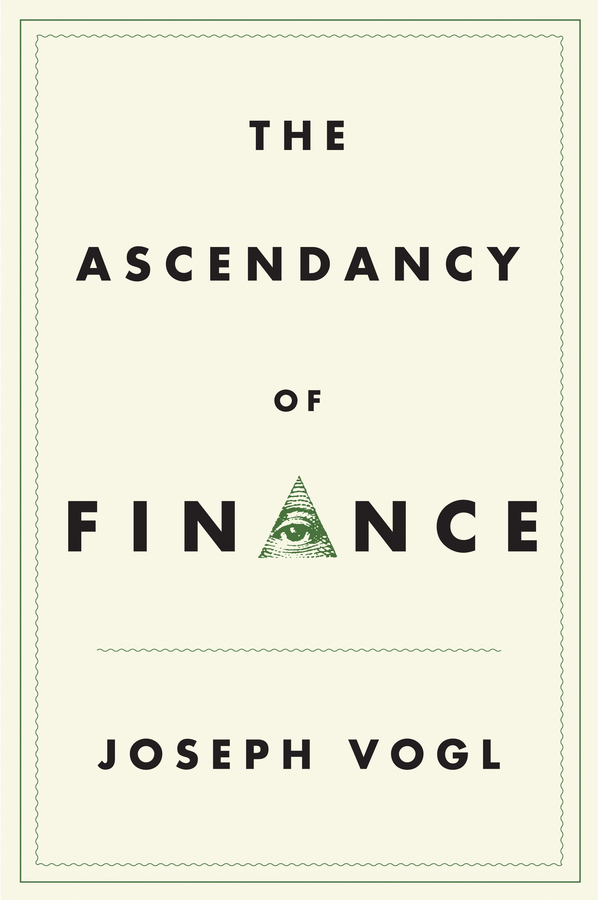
The Ascendancy of Finance The global financial crisis of 2008 ushered in a system of informal decision-making in the grey zone between economics and politics. Legitimized by a rhetoric of emergency, ad hoc bodies have usurped democratically elected governments. In line with the neoliberal credo, the recent crisis has been used to realize the politically impossible and to re-align executive power with the interests of the finance industry. In this important book, Joseph Vogl offers a much longer perspective on these developments, showing how the dynamics of modern finance capitalism have always rested on a complex and constantly evolving relationship between private creditors and the state. Combining historical and theoretical analysis, Vogl argues that over the last three centuries, finance has become a "fourth estate," marked by the systematic interconnection of treasury and finance, of political and private economic interests. Against this historical background, Vogl explores the latest phase in the financialization of government, namely the dramatic transfer of power from states to markets in the latter half of the 20th century. From the liberalization of credit and capital markets to the privatization of social security, he shows how policy has actively enabled a restructuring of the economy around the financial sector. Political systems are "imprisoned" by the regime of finance, while the corporate model suffuses society, enclosing populations in the production of financial capital. The Ascendancy of Finance provides valuable and unsettling insight into the genesis of modern power and where it truly resides. POLITICAL SCIENCE,International Relations,Trade & Tariffs
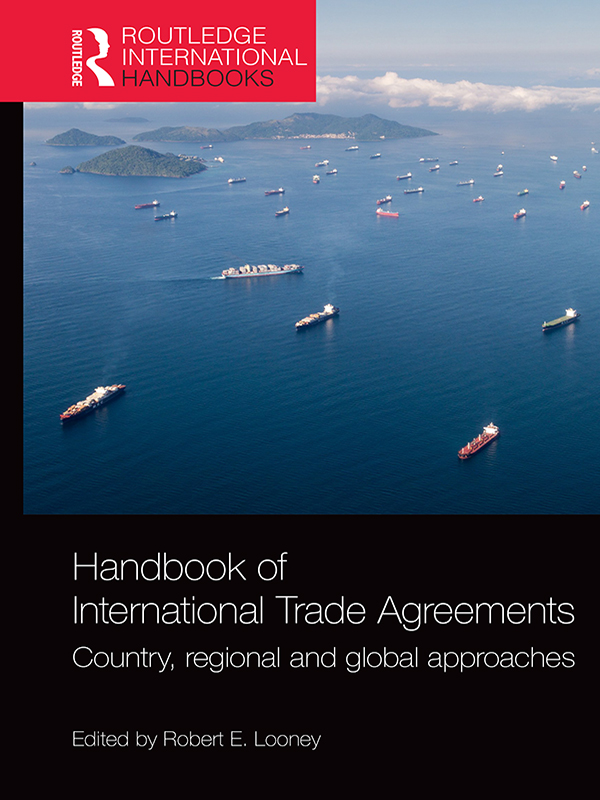
Handbook of International Trade Agreements International trade has, for decades, been central to economic growth and improved standards of living for nations and regions worldwide. For most of the advanced countries, trade has raised standards of living, while for most emerging economies, growth did not begin until their integration into the global economy. The economic explanation is simple: international trade facilitates specialization, increased efficiency and improved productivity to an extent impossible in closed economies. However, recent years have seen a significant slowdown in global trade, and the global system has increasingly come under attack from politicians on the right and on the left. The benefits of open markets, the continuation of international co-operation, and the usefulness of multilateral institutions such as the World Trade Organization (WTO), the International Monetary Fund and the World Bank have all been called into question. While globalization has had a broadly positive effect on overall global welfare, it has also been perceived by the public as damaging communities and social classes in the industrialized world, spawning, for example, Brexit and the US exit from the Trans-Pacific Partnership. The purpose of this volume is to examine international and regional preferential trade agreements (PTAs), which offer like-minded countries a possible means to continue receiving the benefits of economic liberalization and expanded trade. What are the strengths and weaknesses of such agreements, and how can they sustain growth and prosperity for their members in an ever-challenging global economic environment? The Handbook is divided into two parts. The first, Global Themes, offers analysis of issues including the WTO, trade agreements and economic development, intellectual property rights, security and environmental issues, and PTAs and developing countries. The second part examines regional and country-specific agreements and issues, including NAFTA, CARICOM, CETA, the Pacific Alliance, the European Union, EFTA, ECOWAS, SADC, TTIP, RCEP and the TPP (now the CPTPP), as well as the policies of countries such as Japan and Australia. POLITICAL SCIENCE,International Relations,Trade & Tariffs

Ethical Consumption Increasingly, consumers in North America and Europe see their purchasing as a way to express to the commercial world their concerns about trade justice, the environment and similar issues. This ethical consumption has attracted growing attention in the press and among academics. Extending beyond the growing body of scholarly work on the topic in several ways, this volume focuses primarily on consumers rather than producers and commodity chains. It presents cases from a variety of European countries and is concerned with a wide range of objects and types of ethical consumption, not simply the usual tropical foodstuffs, trade justice and the system of fair trade. Contributors situate ethical consumption within different contexts, from common Western assumptions about economy and society, to the operation of ethical-consumption commerce, to the ways that people’s ethical consumption can affect and be affected by their social situation. By locating consumers and their practices in the social and economic contexts in which they exist and that their ethical consumption affects, this volume presents a compelling interrogation of the rhetoric and assumptions of ethical consumption. POLITICAL SCIENCE,International Relations,Trade & Tariffs
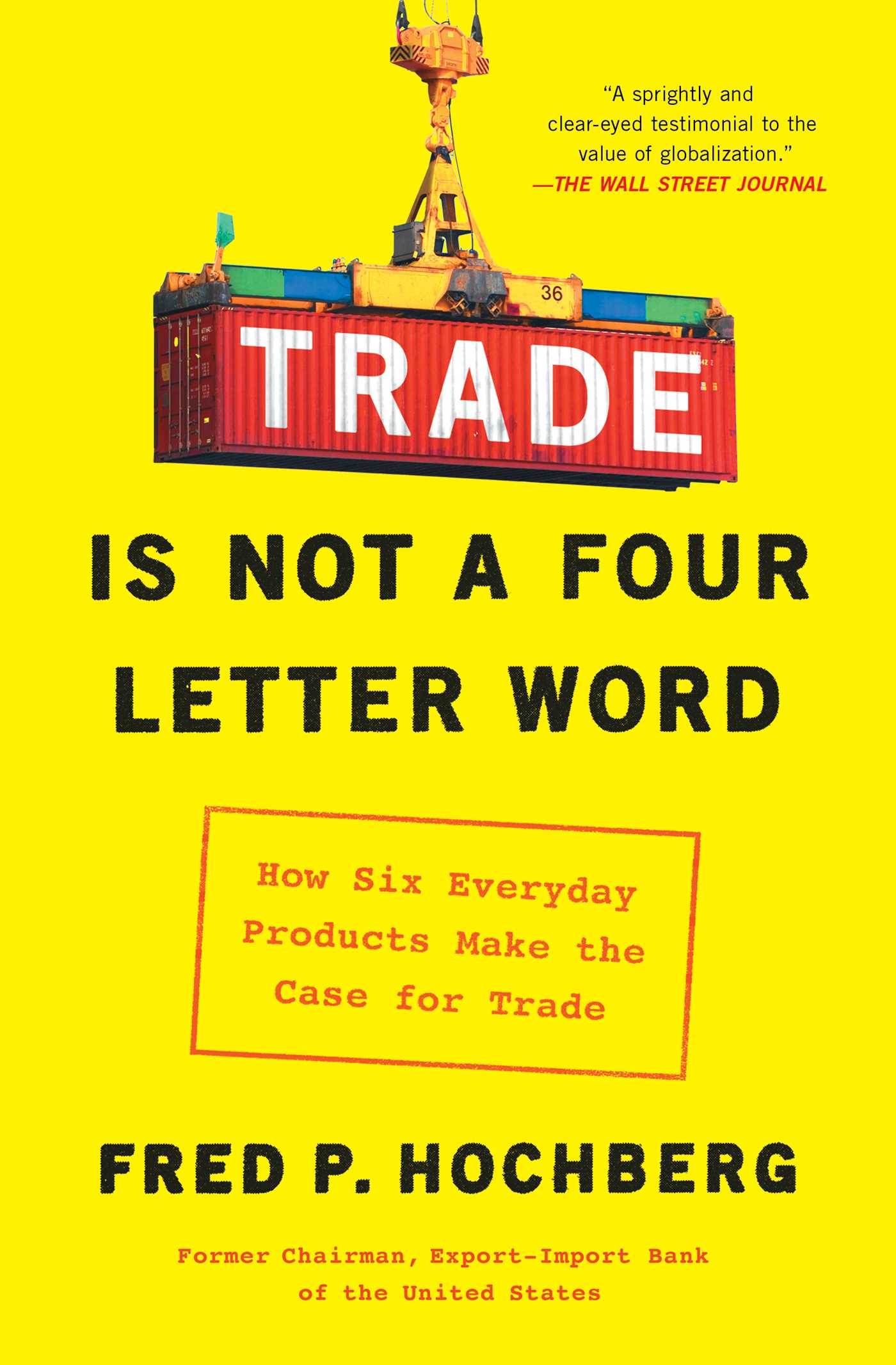
Trade Is Not a Four-Letter Word Trade myths, busted and debunked, with the help of six surprising everyday goods— the taco salad, the Honda Odyssey, the banana, the iPhone, the college degree, and the blockbuster HBO series Game of Thrones Trade allows us to sell what we produce at home and purchase what we don’t. It lowers prices and gives us greater variety and innovation. Yet understanding our place in the global trade network is rarely so simple, and today’s workers are wary of being taken advantage of. Trade has become an easy excuse for struggling economies, a scapegoat for our failures to adapt to a changing world, and—for many Americans on both the right and the left—nothing short of a four-letter word. But as Fred P. Hochberg reminds us, trade is easier to understand than we commonly think. In Trade Is Not a Four-Letter Word, you’ll learn how NAFTA became a populist punching bag on both sides of the aisle. You’ll learn how Americans can avoid the grim specter of the $10 banana. And you’ll finally discover the truth about whether or not, as President Trump once famously tweeted, “trade wars are good and easy to win.†(Spoiler alert—they aren’t.) Hochberg unravels the mysteries of trade by pulling back the curtain on six everyday products, each with a surprising story to tell: the taco salad, the Honda Odyssey, the banana, the iPhone, the college degree, and the smash hit HBO series Game of Thrones. Behind these six examples are stories that help explain not only how trade has shaped our lives so far but also how we can use trade to build a better future for our own families, for America, and for the world. There is no going back. Trade Is Not a Four-Letter Word is the antidote to today’s acronym-laden trade jargon pitched to voters with simple promises that rarely play out so one-dimensionally. It’s time to read between the lines. Packed with colorful examples and highly digestible explanations, Trade Is Not a Four-Letter Word entertains as it dispels popular misconceptions and arms readers with a thorough grasp of the basics of trade. POLITICAL SCIENCE,International Relations,Trade & Tariffs
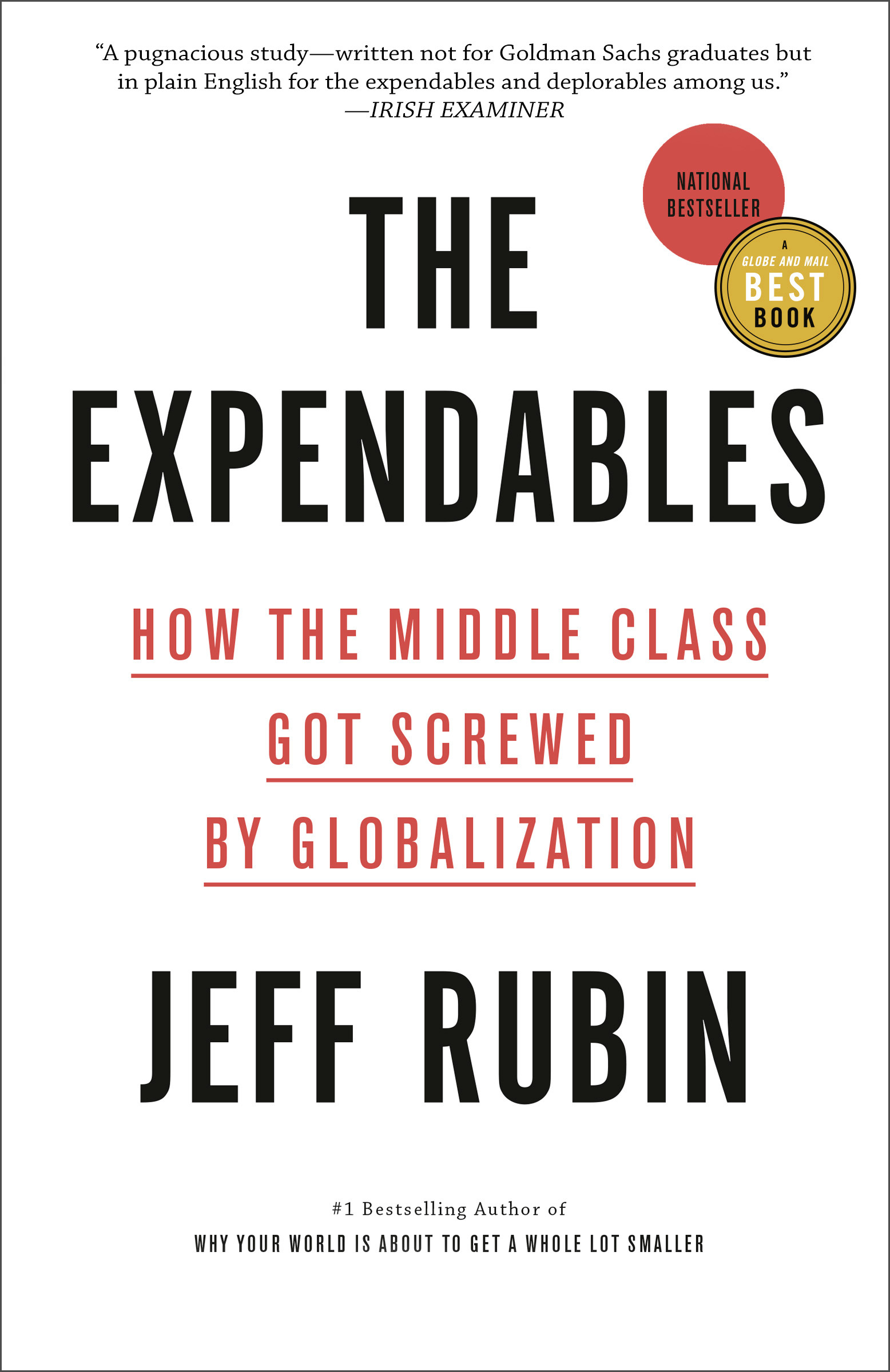
The Expendables From the #1 bestselling author of Why Your World Is About to Get A Whole Lot Smaller , a provocative, far-reaching account of how the middle class got stuck with the bill for globalization, and how the blowback--from Brexit to Trump to populist Europe--will change the developed world. Real wages in North America have not risen since the 1970s. Union membership has collapsed. Full-time employment is beginning to look like a quaint idea from the distant past. If it seems that the middle class is in retreat around the developed world, it is. Former CIBC World Markets Chief Economist Jeff Rubin argues that all this was foreseeable back when Canada, the United States and Mexico first started talking free trade. Labour argued then that manufacturing jobs would move to Mexico. Free-trade advocates disagreed. Today, Canadian and American factories sit idle. More steel is used to make bottlecaps than cars. Meanwhile, Mexico has become one of the world's biggest automotive exporters. And it's not just NAFTA. Cheap oil, low interest rates, global deregulation and tax policies that benefit the rich all have the same effect: the erosion of the middle class. Growing global inequality is a problem of our own making, Rubin argues. And solving it won't be easy if we draw on the same ideas about capital and labour, right and left, that led us to this cliff. Articulating a vision that dovetails with the ideas of both Naomi Klein and Donald Trump, The Expendables is an exhilaratingly fresh perspective that is at once humane and irascible, fearless and rigorous, and most importantly, timely. GDP is growing, the stock market is up and unemployment is down, but the surprise of the book is that even the good news is good for only one percent of us. POLITICAL SCIENCE,International Relations,Trade & Tariffs

Advantage "Thoughtful . . . . [Segal's] striking argument is that the challengers [India and China] lack America's resilient, open and risk-taking culture." —Economist The emergence of India and China as economic powers has shifted the global landscape and called into question the ability of the United States to compete. Advantage sorts out the challenges the United States faces and focuses on what drives innovation, what constrains it, and what strengths we have to leverage. Entirely recasting the stakes of the debate, Adam Segal makes the compelling case for the crucial role of the “software†of innovation. By bolstering its politics, social relations, and institutions that move ideas from the lab to the marketplace, the United States can preserve its position as a global power. With up-to-the minute economic and political data, this is a resounding call to tie innovation to larger social goals in an age of global science and technology. POLITICAL SCIENCE,International Relations,Trade & Tariffs
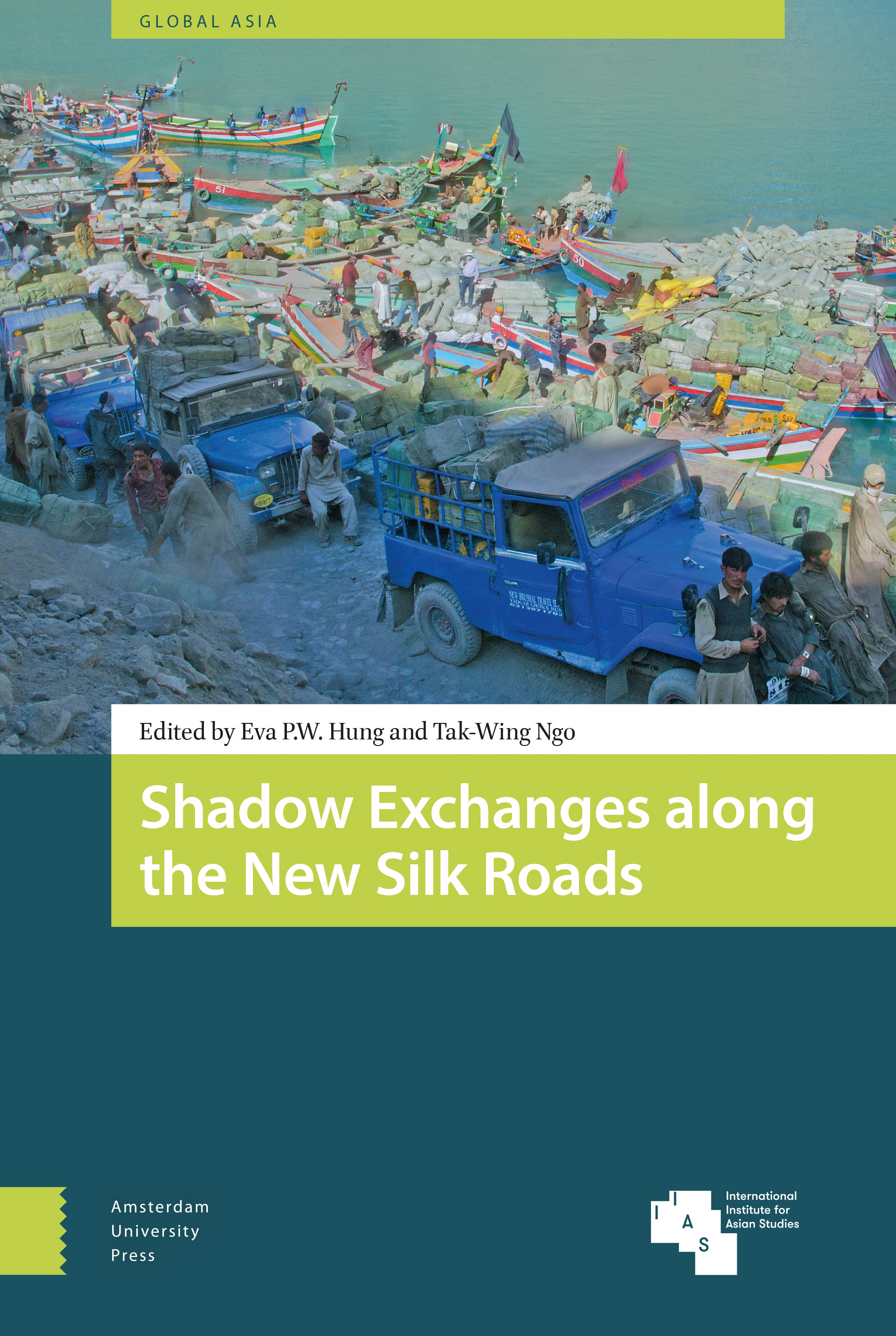
Shadow Exchanges along the New Silk Roads Long before China promulgated the official One Belt One Road initiatives, vast networks of cross-border exchanges already existed across Asia and Eurasia. The dynamics of such trade and resource flows have largely been outside state control, and are pushed to the realm of the shadow economy. The official initiative is a state-driven attempt to enhance the orderly flow of resources across countries along the Belt and Road, hence extending the reach of the states to the shadow economies. This volume offers a bottom-up view of the transborder informal exchanges across Asia and Eurasia, and analyses its clash and mesh with the state-orchestrated Belt and Road cooperation. By undertaking a comparative study of country cases along the new silk roads, the book underlines the intended and unintended consequences of such competing routes of connectivity on the socio-economic conditions of local communities. POLITICAL SCIENCE,International Relations,Trade & Tariffs

Shadowbosses SHADOWBOSSES reads like an organized crime novel, but it's actually a true story of how labor unions are infiltrating our government and corrupting our political process. This compelling and insightful book exposes how unions have organized federal, state, and local government employees without their consent, and how government employee unions are now a threat to our workers' freedoms, our free and fair elections, and even our American way of life. And, Mallory Factor reveals what's coming next: how unions are targeting millions of Americans--maybe even you--for forced unionization so that unions can collect billions more in forced dues and exert an even greater influence over American politics. A chilling expose, SHADOWBOSSES is also a call to citizen action against those who really hold power in America today. POLITICAL SCIENCE,Labor & Industrial Relations
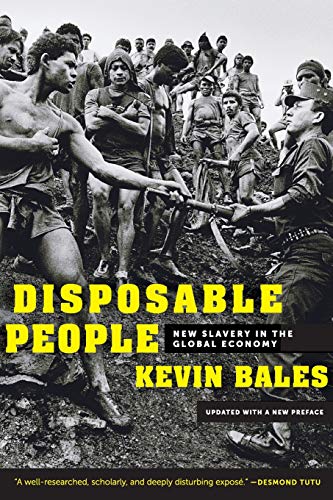
Disposable People Slavery is illegal throughout the world, yet more than twenty-seven million people are still trapped in one of history's oldest social institutions. Kevin Bales's disturbing story of slavery today reaches from brick kilns in Pakistan and brothels in Thailand to the offices of multinational corporations. His investigation of conditions in Mauritania, Brazil, Thailand, Pakistan, and India reveals the tragic emergence of a "new slavery," one intricately linked to the global economy. The new slaves are not a long-term investment as was true with older forms of slavery, explains Bales. Instead, they are cheap, require little care, and are disposable. Three interrelated factors have helped create the new slavery. The enormous population explosion over the past three decades has flooded the world's labor markets with millions of impoverished, desperate people. The revolution of economic globalization and modernized agriculture has dispossessed poor farmers, making them and their families ready targets for enslavement. And rapid economic change in developing countries has bred corruption and violence, destroying social rules that might once have protected the most vulnerable individuals. Bales's vivid case studies present actual slaves, slaveholders, and public officials in well-drawn historical, geographical, and cultural contexts. He observes the complex economic relationships of modern slavery and is aware that liberation is a bitter victory for a child prostitute or a bondaged miner if the result is starvation. Bales offers suggestions for combating the new slavery and provides examples of very positive results from organizations such as Anti-Slavery International, the Pastoral Land Commission in Brazil, and the Human Rights Commission in Pakistan. He also calls for researchers to follow the flow of raw materials and products from slave to marketplace in order to effectively target campaigns of "naming and shaming" corporations linked to slavery. Disposable People is the first book to point the way to abolishing slavery in today's global economy. All of the author's royalties from this book go to fund anti-slavery projects around the world. POLITICAL SCIENCE,Labor & Industrial Relations
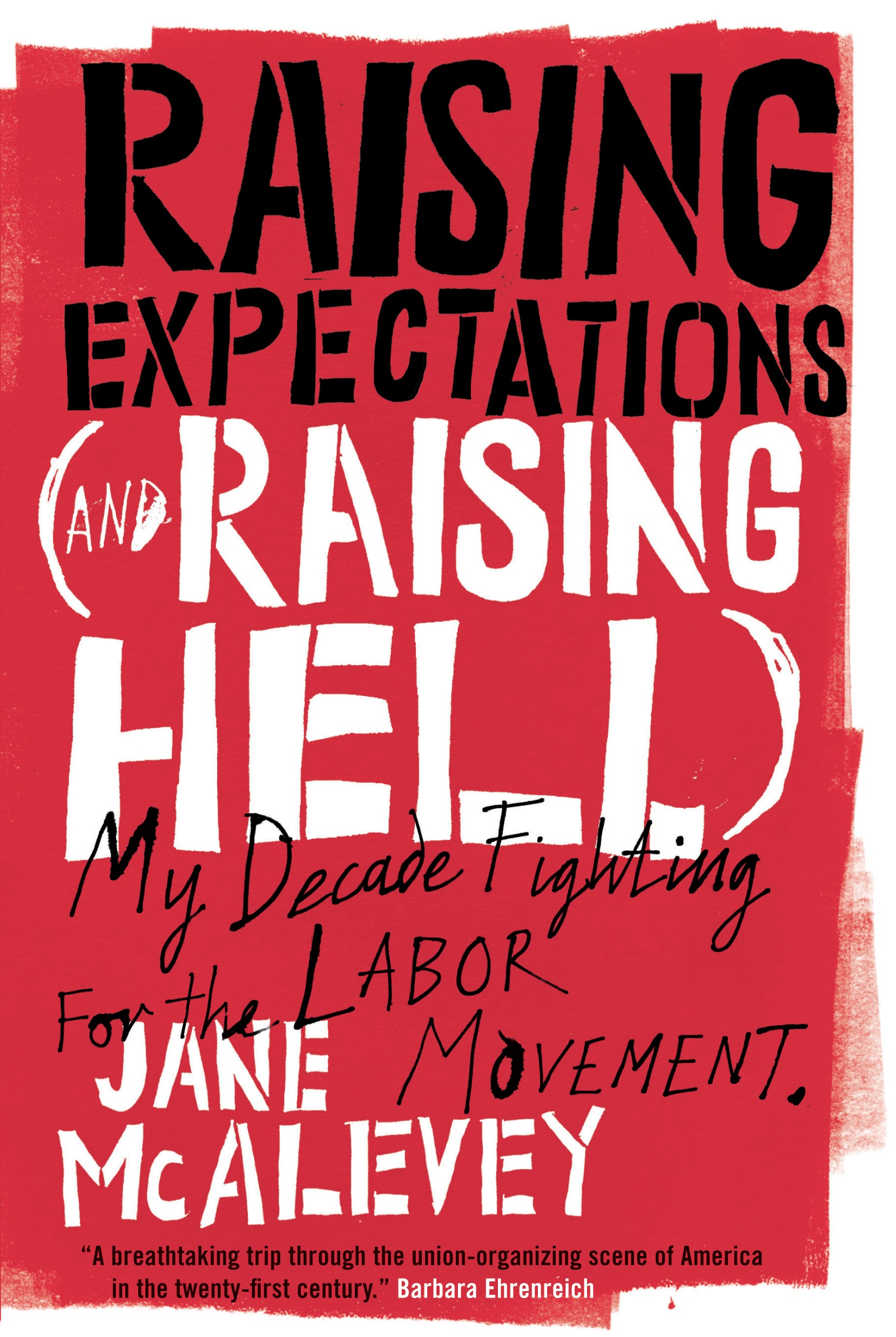
Raising Expectations (and Raising Hell) In 1995, in the first contested election in the history ofthe AFL-CIO, John Sweeney won the presidency of the nation’s largest laborfederation, promising renewal and resurgence. Today, less than 7 percent ofAmerican private-sector workers belong to a union, the lowest percentage sincethe beginning of the twentieth century, and public employee collectivebargaining has been dealt devastating blows in Wisconsin and elsewhere. Whathappened? Jane McAlevey is famous—and notorious—in the American labormovement as the hard-charging organizer who racked up a string of victories ata time when union leaders said winning wasn’t possible. Then she was bouncedfrom the movement, a victim of the high-level internecine warfare that has tornapart organized labor. In this engrossing and funny narrative—that reflects thepersonality of its charismatic, wisecracking author—McAlevey tells the story ofa number of dramatic organizing and contract victories, and the unconventionalstrategies that helped achieve them. Raising Expectations (And Raising Hell)argues that labor can be revived, but only if the movement acknowledges itsmistakes and fully commits to deep organizing, participatory education, militancy,and an approach to workers and their communities that more resembles the campaignsof the 1930s—in short, social movement unionism that involves raising workers’expectations (while raising hell). POLITICAL SCIENCE,Labor & Industrial Relations
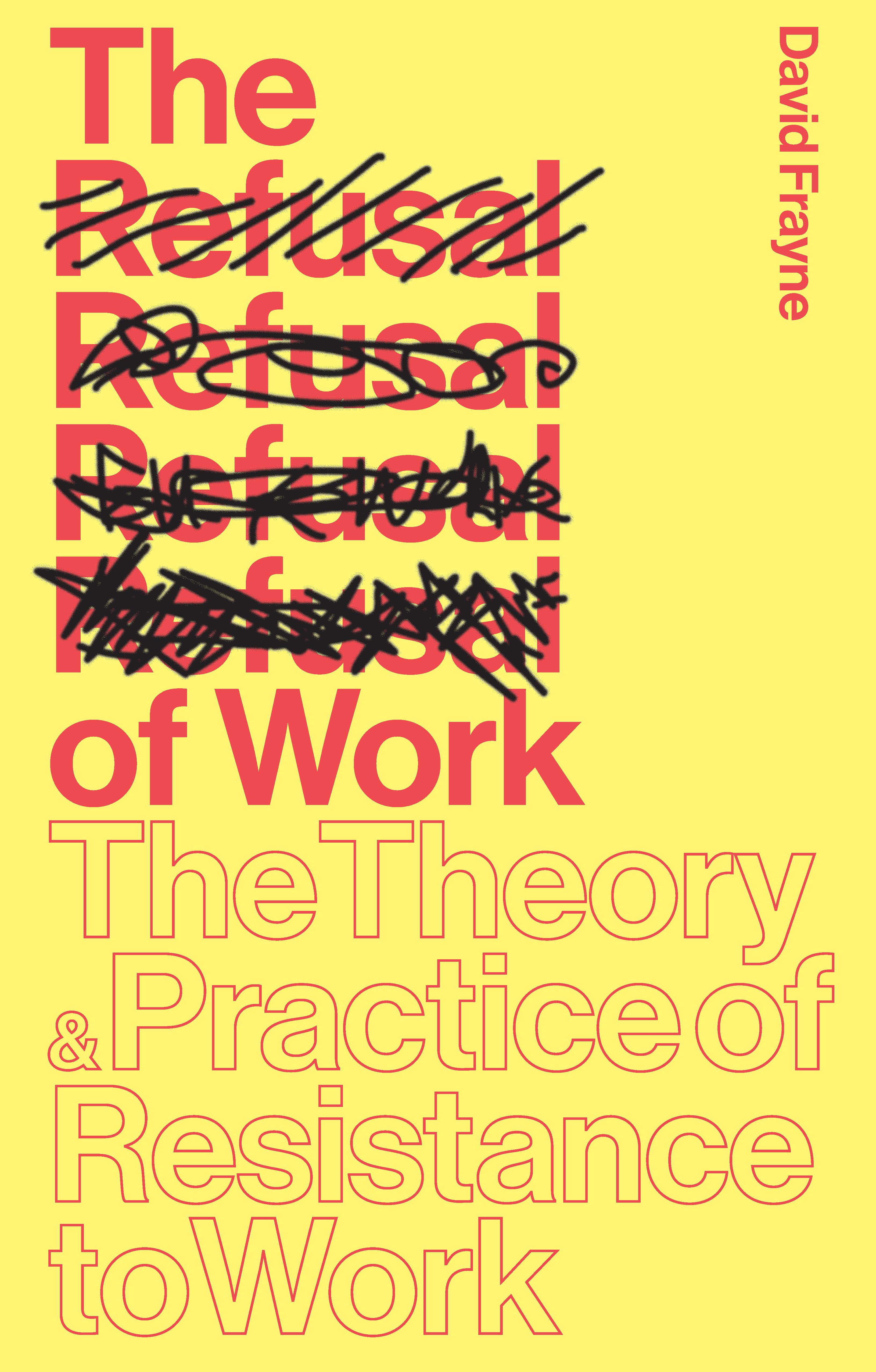
The Refusal of Work The Refusal of Work argues that the time has come to challenge the political and cultural centrality of paid work. POLITICAL SCIENCE,Labor & Industrial Relations
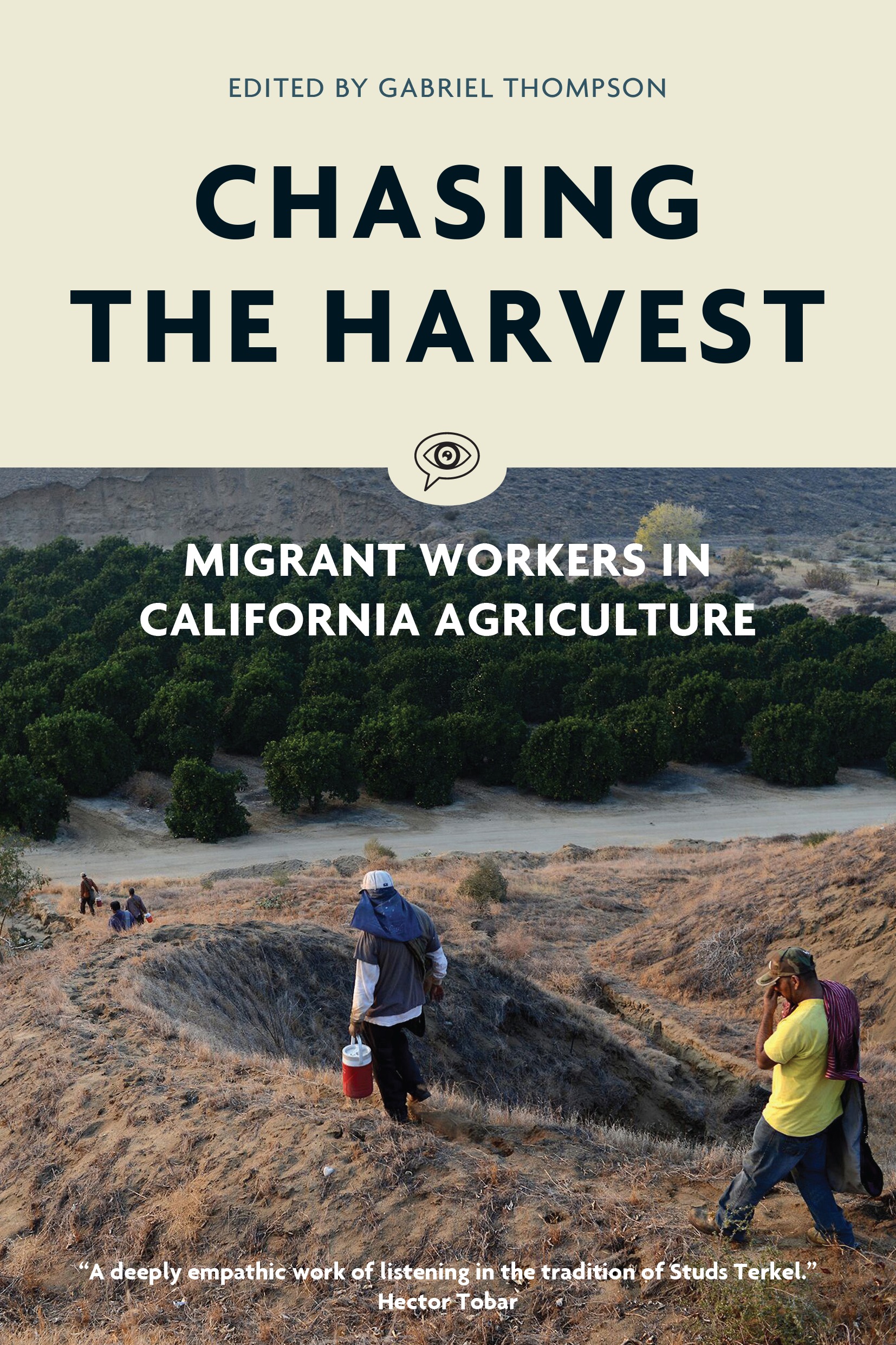
Chasing the Harvest Lives from an invisible community—the migrant farmworkers of the United States The Grapes of Wrath brought national attention to the condition of California’s migrant farmworkers in the 1930s. Cesar Chavez and the United Farm Workers’ grape and lettuce boycotts captured the imagination of the United States in the 1960s and ’70s. Yet today, the stories of the more than 800,000 men, women, and children working in California’s fields—one third of the nation’s agricultural work force—are rarely heard, despite the persistence of wage theft, dangerous working conditions, and uncertain futures. This book of oral histories makes the reality of farm work visible in accounts of hardship, bravery, solidarity, and creativity in California’s fields, as real people struggle to win new opportunities for future generations. Among the narrators: Maricruz, a single mother fired from a packing plant after filing a sexual assault complaint against her supervisor. Roberto, a vineyard laborer in the scorching Coachella Valley who became an advocate for more humane working conditions after his teenage son almost died of heatstroke. Oscar, an elementary school teacher in Salinas who wants to free his students from a life in the fields, the fate that once awaited him as a child. POLITICAL SCIENCE,Labor & Industrial Relations
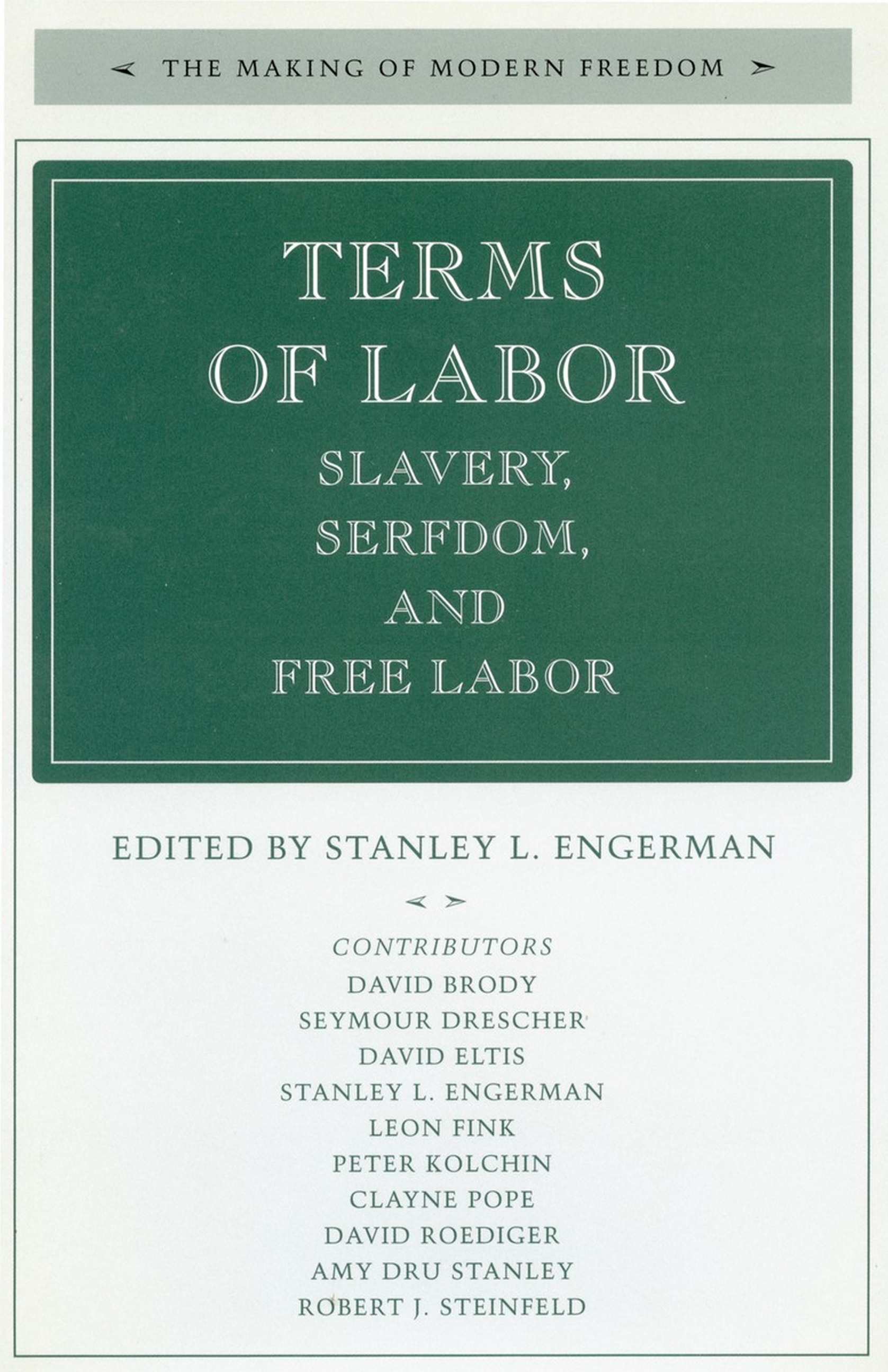
Terms of Labor This volume deals with the general issues of the causes and consequences of the rise of so-called free labor from slavery and serfdom in Europe, the United States, and the Caribbean over the past four to five centuries, and points to the many complications and paradoxical aspects of this change. POLITICAL SCIENCE,Labor & Industrial Relations

Resilient Health Care, Volume 2 Health systems everywhere are expected to meet increasing public and political demands for accessible, high-quality care. Policy-makers, managers, and clinicians use their best efforts to improve efficiency, safety, quality, and economic viability. One solution has been to mimic approaches that have been shown to work in other domains, such as quality management, lean production, and high reliability. In the enthusiasm for such solutions, scant attention has been paid to the fact that health care as a multifaceted system differs significantly from most traditional industries. Solutions based on linear thinking in engineered systems do not work well in complicated, multi-stakeholder non-engineered systems, of which health care is a leading example. A prerequisite for improving health care and making it more resilient is that the nature of everyday clinical work be well understood. Yet the focus of the majority of policy or management solutions, as well as that of accreditation and regulation, is work as it ought to be (also known as ’work-as-imagined’). The aim of policy-makers and managers, whether the priority is safety, quality, or efficiency, is therefore to make everyday clinical work - or work-as-done - comply with work-as-imagined. This fails to recognise that this normative conception of work is often oversimplified, incomplete, and outdated. There is therefore an urgent need to better understand everyday clinical work as it is done. Despite the common focus on deviations and failures, it is undeniable that clinical work goes right far more often than it goes wrong, and that we only can make it better if we understand how this happens. This second volume of Resilient Health Care continues the line of thinking of the first book, but takes it further through a range of chapters from leading international thinkers on resilience and health care. Where the first book provided the rationale and basic concepts of RHC, the Resilience of Everyday Clinical Work b POLITICAL SCIENCE,Labor & Industrial Relations
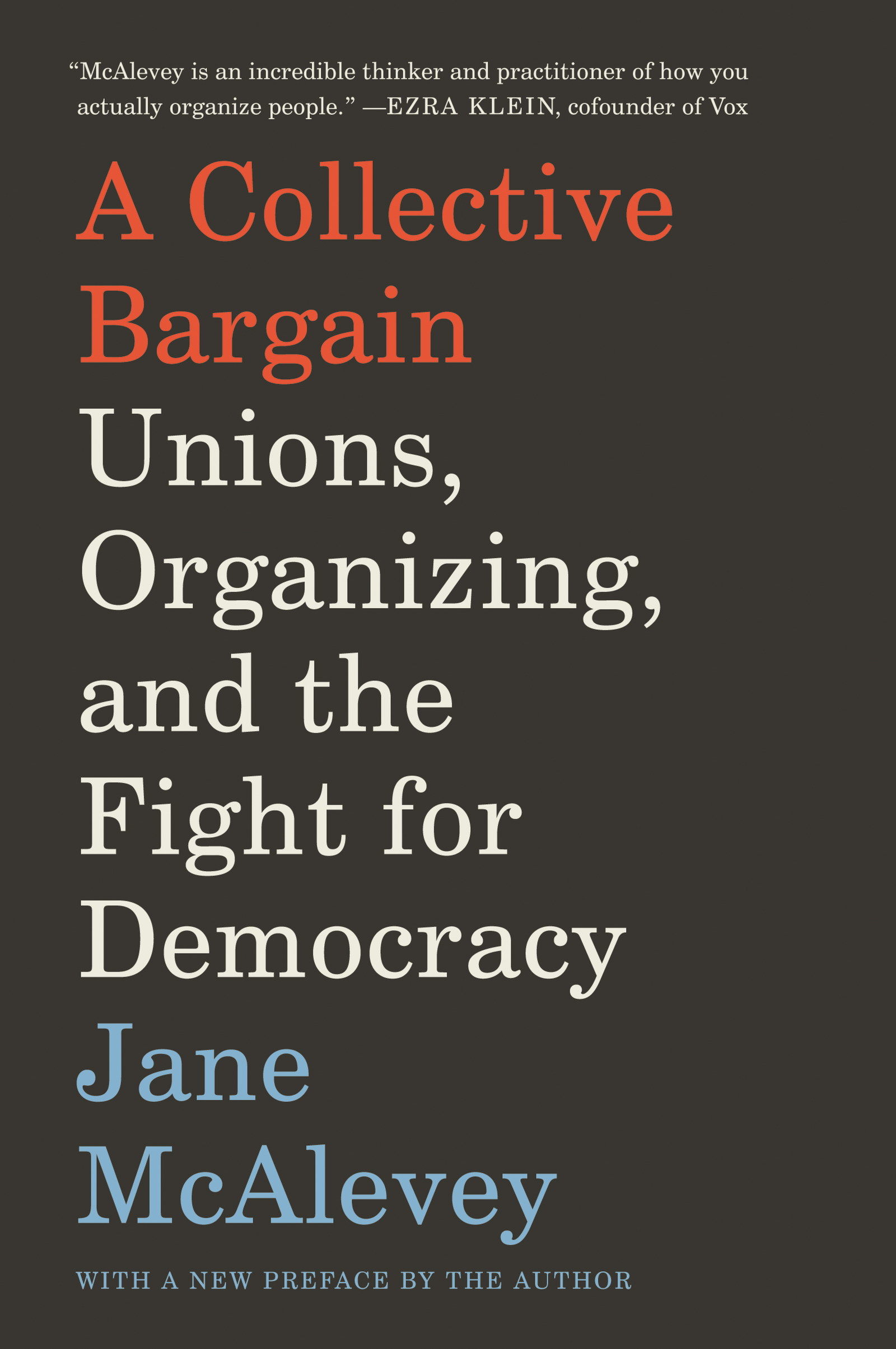
A Collective Bargain From longtime labor organizer Jane McAlevey, a vital call-to-arms in favor of unions, a key force capable of defending our democracy For decades, racism, corporate greed, and a skewed political system have been eating away at the social and political fabric of the United States. Yet as McAlevey reminds us, there is one weapon whose effectiveness has been proven repeatedly throughout U.S. history: unions. In A Collective Bargain, longtime labor organizer, environmental activist, and political campaigner Jane McAlevey makes the case that unions are a key institution capable of taking effective action against today’s super-rich corporate class. Since the 1930s, when unions flourished under New Deal protections, corporations have waged a stealthy and ruthless war against the labor movement. And they’ve been winning. Until today. Because, as McAlevey shows, unions are making a comeback. Want to reverse the nation’s mounting wealth gap? Put an end to sexual harassment in the workplace? End racial disparities on the job? Negotiate climate justice? Bring back unions. As McAlevey travels from Pennsylvania hospitals, where nurses are building a new kind of patient-centered unionism, to Silicon Valley, where tech workers have turned to old-fashioned collective action, to the battle being waged by America’s teachers, readers have a ringside seat at the struggles that will shape our country—and our future. POLITICAL SCIENCE,Labor & Industrial Relations

Red State Revolt An indispensable window into the changing shape of the American working class and American politics Thirteen months after Trump allegedly captured the allegiance of “the white working class,” a strike wave—the first in over four decades—rocked the United States. Inspired by the wildcat victory in West Virginia, teachers in Oklahoma, Arizona, and across the country walked off their jobs and shut down their schools to demand better pay for educators, more funding for students, and an end to years of austerity. Confounding all expectations, these working-class rebellions erupted in regions with Republican electorates, weak unions, and bans on public sector strikes. By mobilizing to take their destinies into their own hands, red state school workers posed a clear alternative to politics as usual. And with similar actions now gaining steam in Los Angeles, Oakland, Denver, and Virginia, there is no sign that this upsurge will be short-lived. Red State Revolt is a compelling analysis of the emergence and development of this historic strike wave, with an eye to extracting its main strategic lessons for educators, labor organizer, and radicals across the country. A former high school teacher and longtime activist, Eric Blanc embedded himself into the rank-and-file leaderships of the walkouts, where he was given access to internal organizing meetings and secret Facebook groups inaccessible to most journalists. The result is one of the richest portraits of the labor movement to date, a story populated with the voices of school workers who are winning the fight for the soul of public education—and redrawing the political map of the country at large. POLITICAL SCIENCE,Labor & Industrial Relations
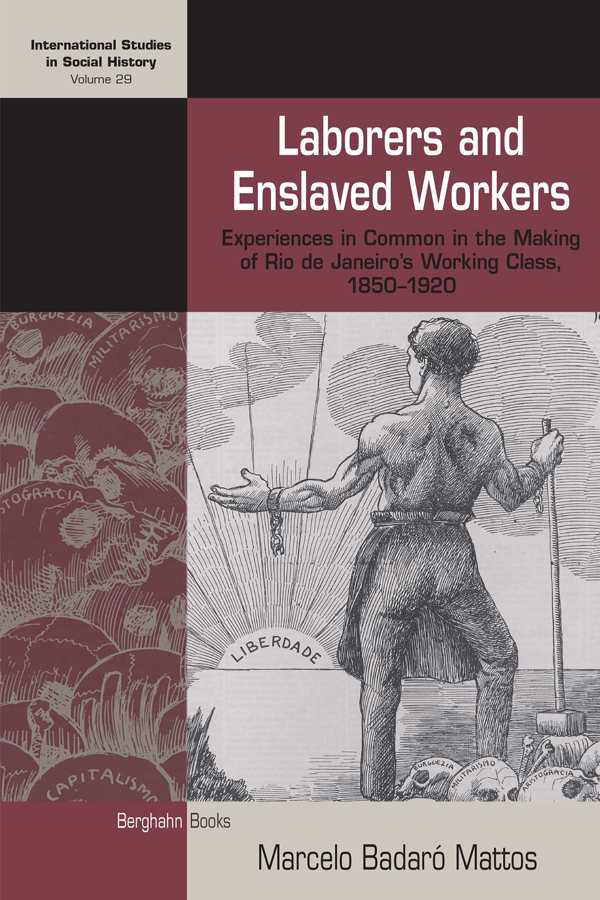
Laborers and Enslaved Workers From the middle of the nineteenth century until the 1888 abolition of slavery in Brazil, Rio de Janeiro was home to the largest urban population of enslaved workers anywhere in the Americas. It was also the site of an incipient working-class consciousness that expressed itself across seemingly distinct social categories. In this volume, Marcelo Badaró Mattos demonstrates that these two historical phenomena cannot be understood in isolation. Drawing on a wide range of historical sources, Badaró Mattos reveals the diverse labor arrangements and associative life of Rio’s working class, from which emerged the many strategies that workers both free and unfree pursued in their struggles against oppression. POLITICAL SCIENCE,Labor & Industrial Relations
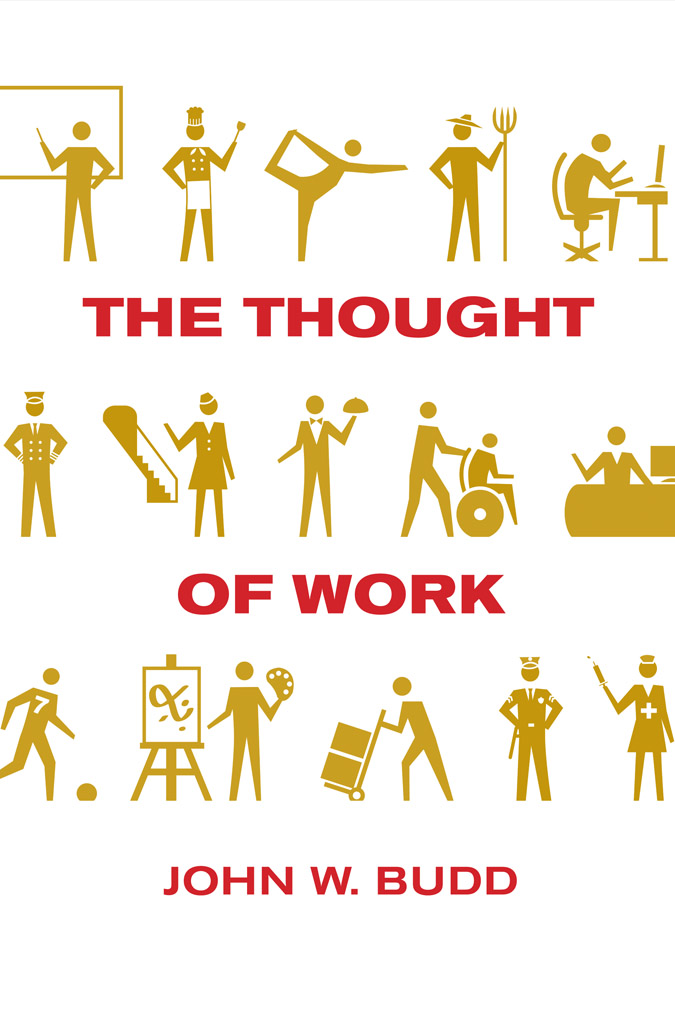
The Thought of Work By drawing explicit attention to diverse, implicit meanings of work, The Thought of Work allows us to better understand work, to value it, and to structure it in desirable ways that reflect its profound importance. POLITICAL SCIENCE,Labor & Industrial Relations
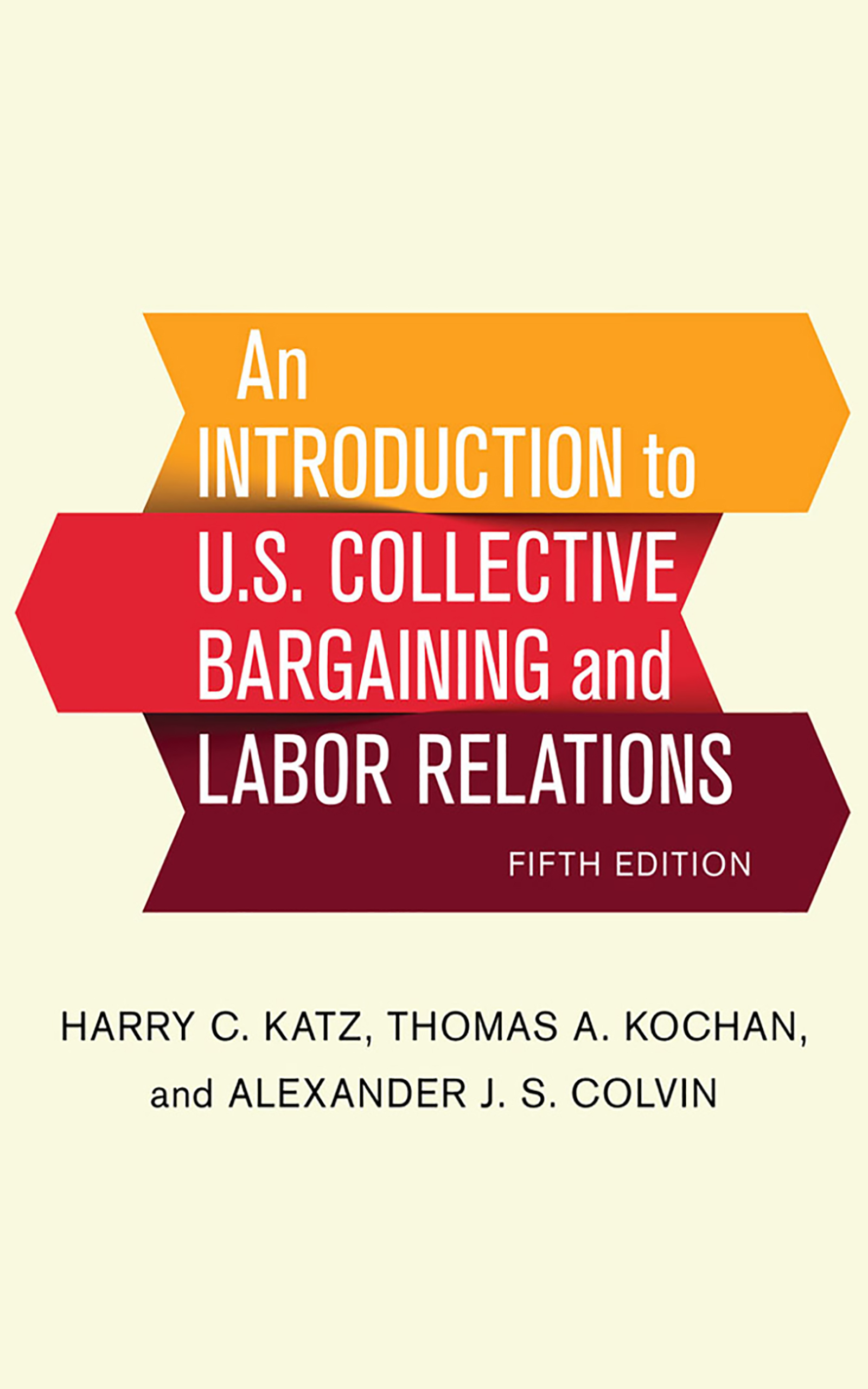
An Introduction to U.S. Collective Bargaining and Labor Relations This comprehensive textbook provides an introduction to collective bargaining and labor relations with a focus on developments in the United States. It is appropriate for students, policy analysts, and labor relations professionals including unionists, managers, and neutrals. A three-tiered strategic choice framework unifies the text, and the authors’ thorough grounding in labor history and labor law assists students in learning the basics. In addition to traditional labor relations, the authors address emerging forms of collective representation and movements that address income inequality in novel ways. Harry C. Katz, Thomas A. Kochan, and Alexander J. S. Colvin provide numerous contemporary illustrations of business and union strategies. They consider the processes of contract negotiation and contract administration with frequent comparisons to nonunion practices and developments, and a full chapter is devoted to special aspects of the public sector. An Introduction to U.S. Collective Bargaining and Labor Relations has an international scope, covering labor rights issues associated with the global supply chain as well as the growing influence of NGOs and cross-national unionism. The authors also compare how labor relations systems in Germany, Japan, China, India, Brazil, and South Africa compare to practices in the United States. The textbook is supplemented by a website (ilr.cornell.edu/scheinman-institute) that features an extensive Instructor’s Manual with a test bank, PowerPoint chapter outlines, mock bargaining exercises, organizing cases, grievance cases, and classroom-ready current events materials. POLITICAL SCIENCE,Labor & Industrial Relations
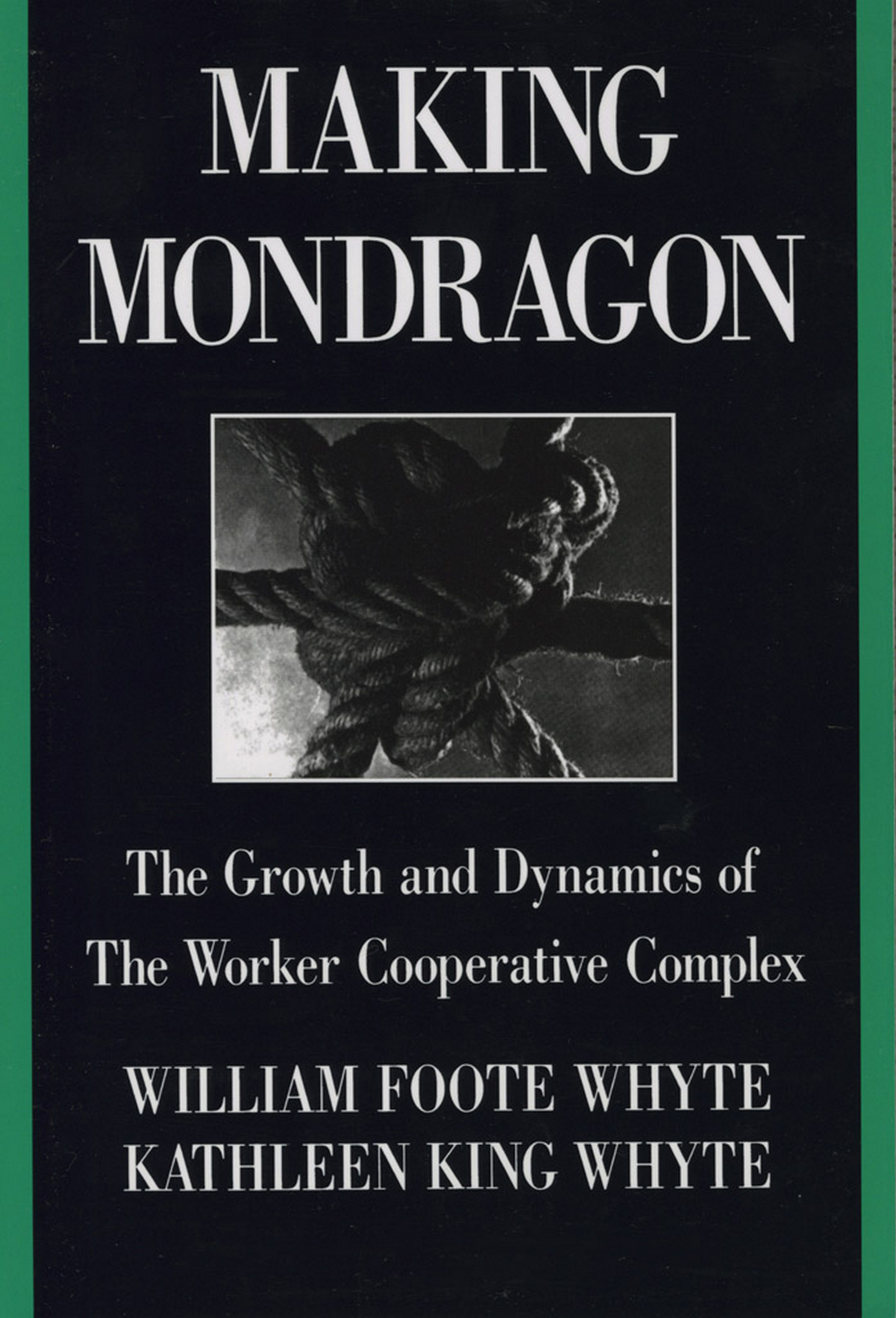
Making Mondragón Making Mondragón is a groundbreaking look at the history of worker ownership in the Spanish cooperative. First published in 1988, it remains the best source for those looking to glean a rich body of ideas for potential adaptation and implementation elsewhere from Mondragón's long and varied experience. POLITICAL SCIENCE,Labor & Industrial Relations

Out of Practice Primary care medicine, as we know and remember it, is in crisis. While policymakers, government administrators, and the health insurance industry pay lip service to the personal relationship between physician and patient, dissatisfaction and disaffection run rampant among primary care doctors, and medical students steer clear in order to pursue more lucrative specialties. Patients feel helpless, well aware that they are losing a valued close connection as health care steadily becomes more transactional than relational. The thin-margin efficiency, rapid pace, and high volume demanded by the new health care economics do not work for primary care, an inherently slower, more personal, and uniquely tailored service. In Out of Practice, Dr. Frederick Barken juxtaposes his personal experience with the latest research on the transformations in the medical field. He offers a cool critique of the "market model of medicine" while vividly illustrating how the seemingly inexorable trend toward specialization in the last few decades has shifted emphasis away from what was once the foundation of medical practice. Dr. Barken addresses the complexities of modern practice—overuse of diagnostic studies, fragmentation of care, increasing reliance on an array of prescription drugs, and the practice of defensive medicine. He shows how changes in medicine, the family, and society have left physicians to deal with a wide range of geriatric issues, from limited mobility to dementia, that are not addressed by health care policy and are not entirely amenable to a physician’s prescription. Indeed, Dr. Barken contends, the very survival of primary care is in jeopardy at a time when its practitioners are needed more than ever. Illustrated with case studies gleaned from more than twenty years in private practice and data from a wide range of sources, Out of Practice is more than a jeremiad about a broken system. Throughout, Dr. Barken offers cogent suggestions for policymakers and practitioners alike, making clear that as valuable as the latest drug or medical device may be, a successful health care system depends just as much on the doctor-patient relationship embodied by primary care medicine. POLITICAL SCIENCE,Labor & Industrial Relations
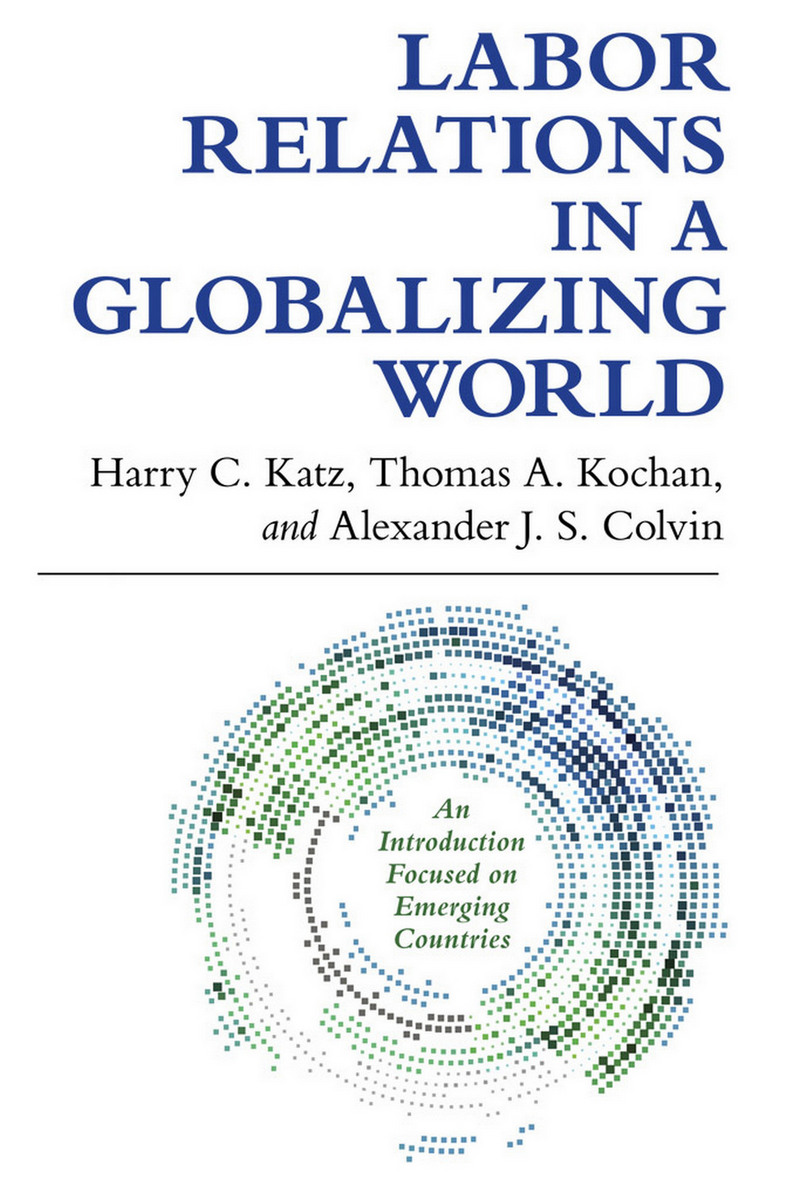
Labor Relations in a Globalizing World This is the first textbook to focus on the workplace outcomes of the production of goods and services in emerging countries. POLITICAL SCIENCE,Labor & Industrial Relations
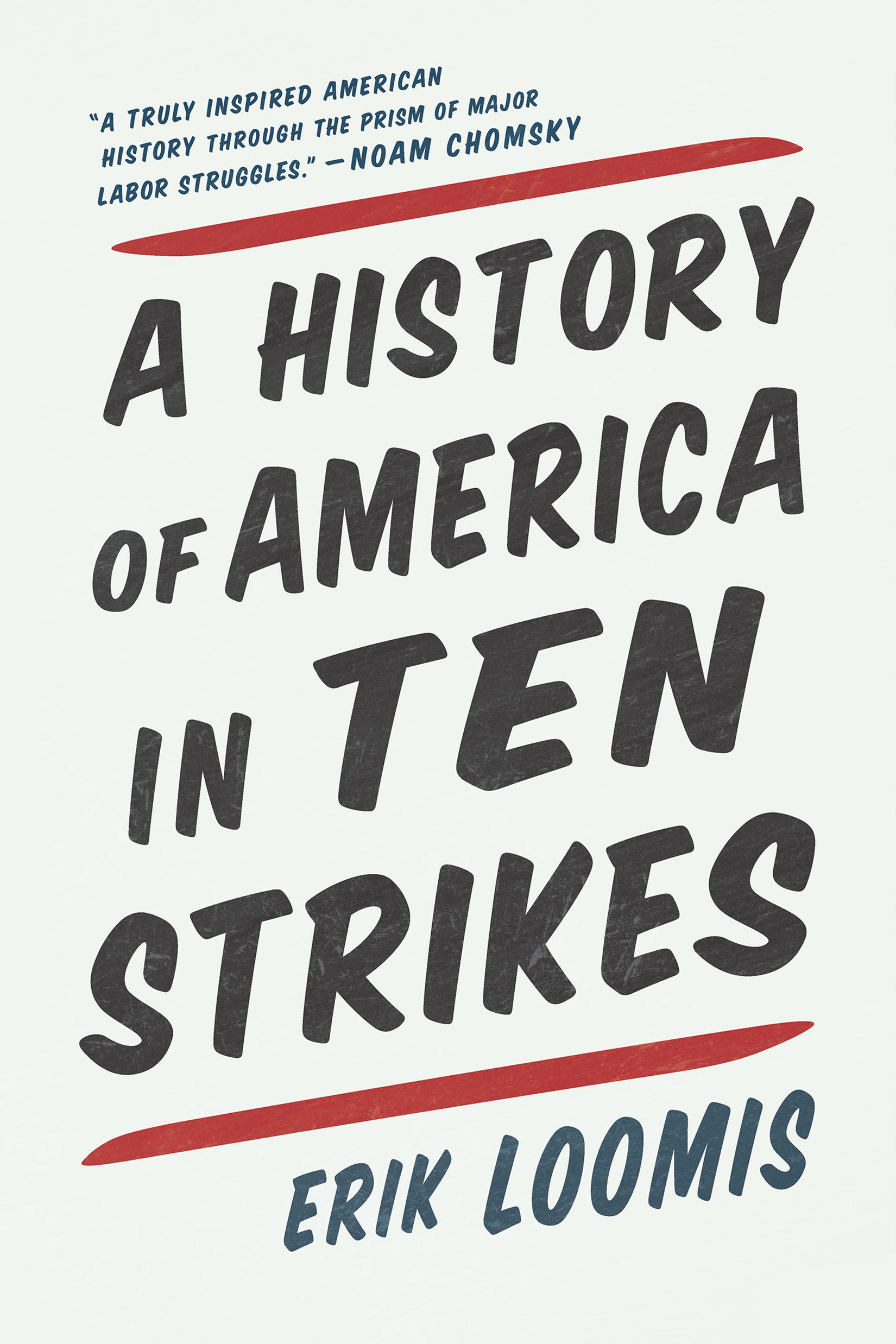
A History of America in Ten Strikes Recommended by The Nation, the New Republic, Current Affairs, Bustle, In These Times "Entertaining, tough-minded, strenuously argued." —The Nation A thrilling and timely account of ten moments in history when labor challenged the very nature of power in America, by the author called “a brilliant historian†by The Progressive magazine Powerful and accessible, A History of America in Ten Strikes challenges all of our contemporary assumptions around labor, unions, and American workers. In this brilliant book, labor historian Erik Loomis recounts ten critical workers’ strikes in American labor history that everyone needs to know about (and then provides an annotated list of the 150 most important moments in American labor history in the appendix). From the Lowell Mill Girls strike in the 1830s to Justice for Janitors in 1990, these labor uprisings do not just reflect the times in which they occurred, but speak directly to the present moment. For example, we often think that Lincoln ended slavery by proclaiming the slaves emancipated, but Loomis shows that they freed themselves during the Civil War by simply withdrawing their labor. He shows how the hopes and aspirations of a generation were made into demands at a GM plant in Lordstown in 1972. And he takes us to the forests of the Pacific Northwest in the early nineteenth century where the radical organizers known as the Wobblies made their biggest inroads against the power of bosses. But there were also moments when the movement was crushed by corporations and the government; Loomis helps us understand the present perilous condition of American workers and draws lessons from both the victories and defeats of the past. In crystalline narratives, labor historian Erik Loomis lifts the curtain on workers’ struggles, giving us a fresh perspective on American history from the boots up. Strikes include: Lowell Mill Girls Strike (Massachusetts, 1830–40) Slaves on Strike (The Confederacy, 1861–65) The Eight-Hour Day Strikes (Chicago, 1886) The Anthracite Strike (Pennsylvania, 1902) The Bread and Roses Strike (Massachusetts, 1912) The Flint Sit-Down Strike (Michigan, 1937) The Oakland General Strike (California, 1946) Lordstown (Ohio, 1972) Air Traffic Controllers (1981) Justice for Janitors (Los Angeles, 1990) POLITICAL SCIENCE,Labor & Industrial Relations

Stolen A must-read polemic about why the 'recovery' from the 2007-08 crash mostly benefited the 1%, and how democratic socialism can save us from a new crash and climate catastrophe. For decades, it has been easier to imagine the end of the world than the end of capitalism. In the decade leading up to the 2008 financial crisis, booming banks, rising house prices and cheap consumer goods propped up living standards in the rich world. Thirty years of rocketing debt and financial wizardry had masked the deep underlying fragility of finance-led growth, and in 2008 we were forced to pay up. The decade since has witnessed all kinds of morbid symptoms, as all around the rich world, wages and productivity are stagnant, inequality is rising, and ecological systems are collapsing. Stolen is a history of finance-led growth and a guide as to how we might escape it. We've sat back as financial capitalism has stolen our economies, our environment and even the future itself. Now, we have an opportunity to change course. What happens next is up to us. POLITICAL SCIENCE,Labor & Industrial Relations

Capital Moves Find a pool of cheap, pliable workers and give them jobs—and soon they cease to be as cheap or as pliable. What is an employer to do then? Why, find another poor community desperate for work. This route—one taken time and again by major American... POLITICAL SCIENCE,Labor & Industrial Relations
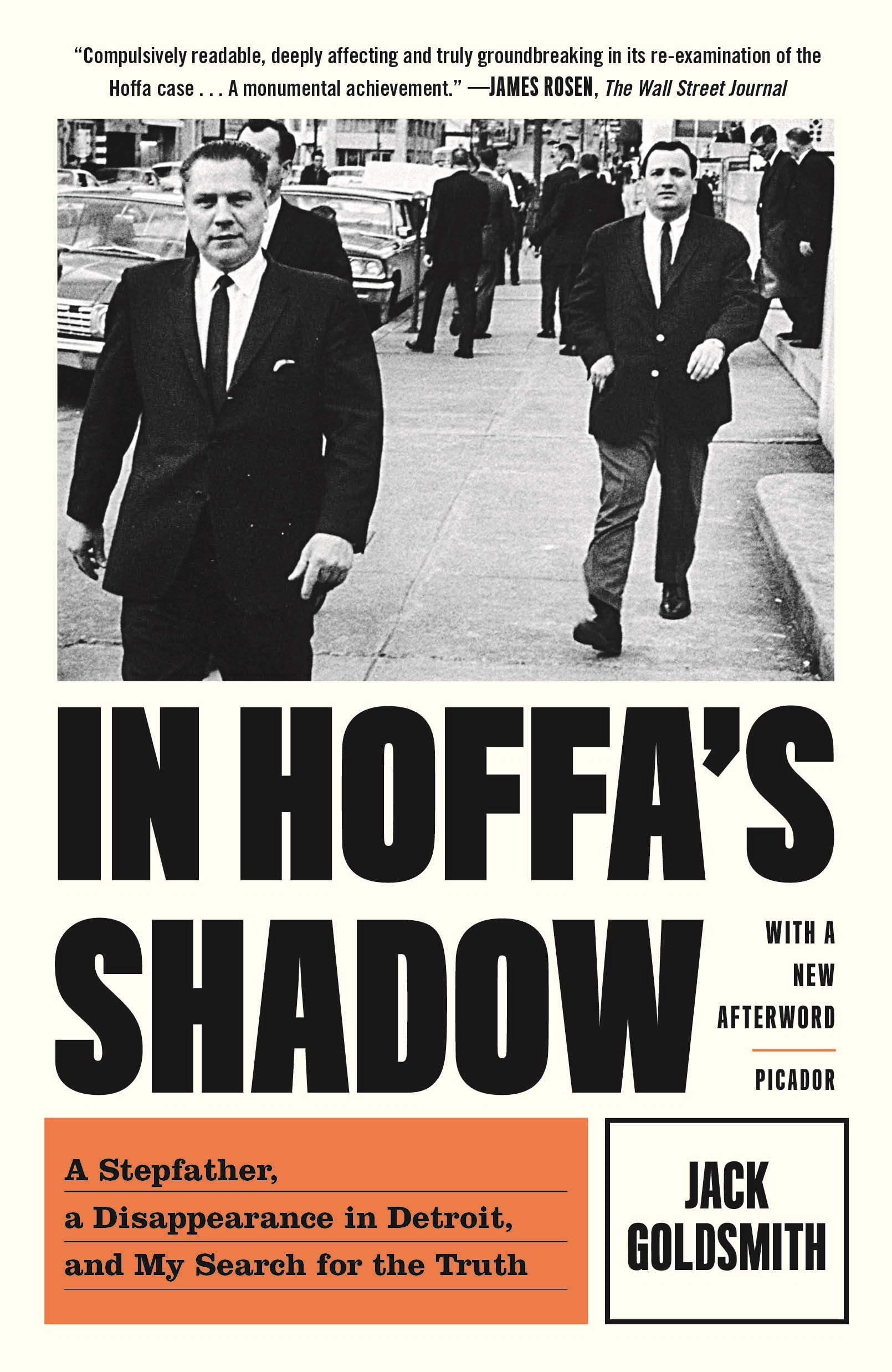
In Hoffa's Shadow The untold story of Charles “Chuckie†O’Brien, Jimmy Hoffa’s right-hand man and suspected killer, told by O’Brien’s distinguished stepson. POLITICAL SCIENCE,Labor & Industrial Relations
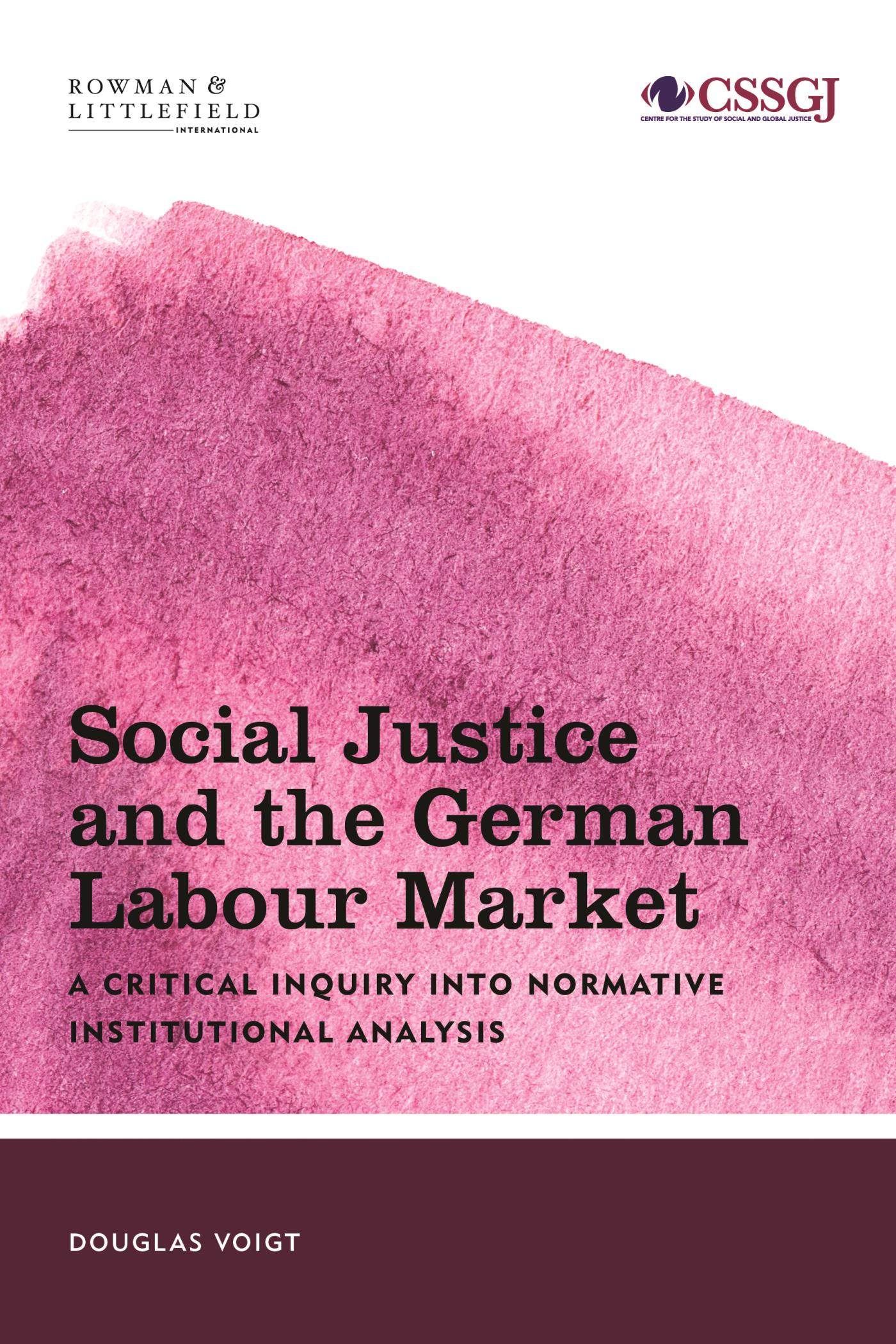
Social Justice and the German Labour Market Offers a critical framework built on the epistemology of Frankfurt School scholars identifying the normative assumptions omnipresent in current causal and explanatory empirical studies POLITICAL SCIENCE,Labor & Industrial Relations
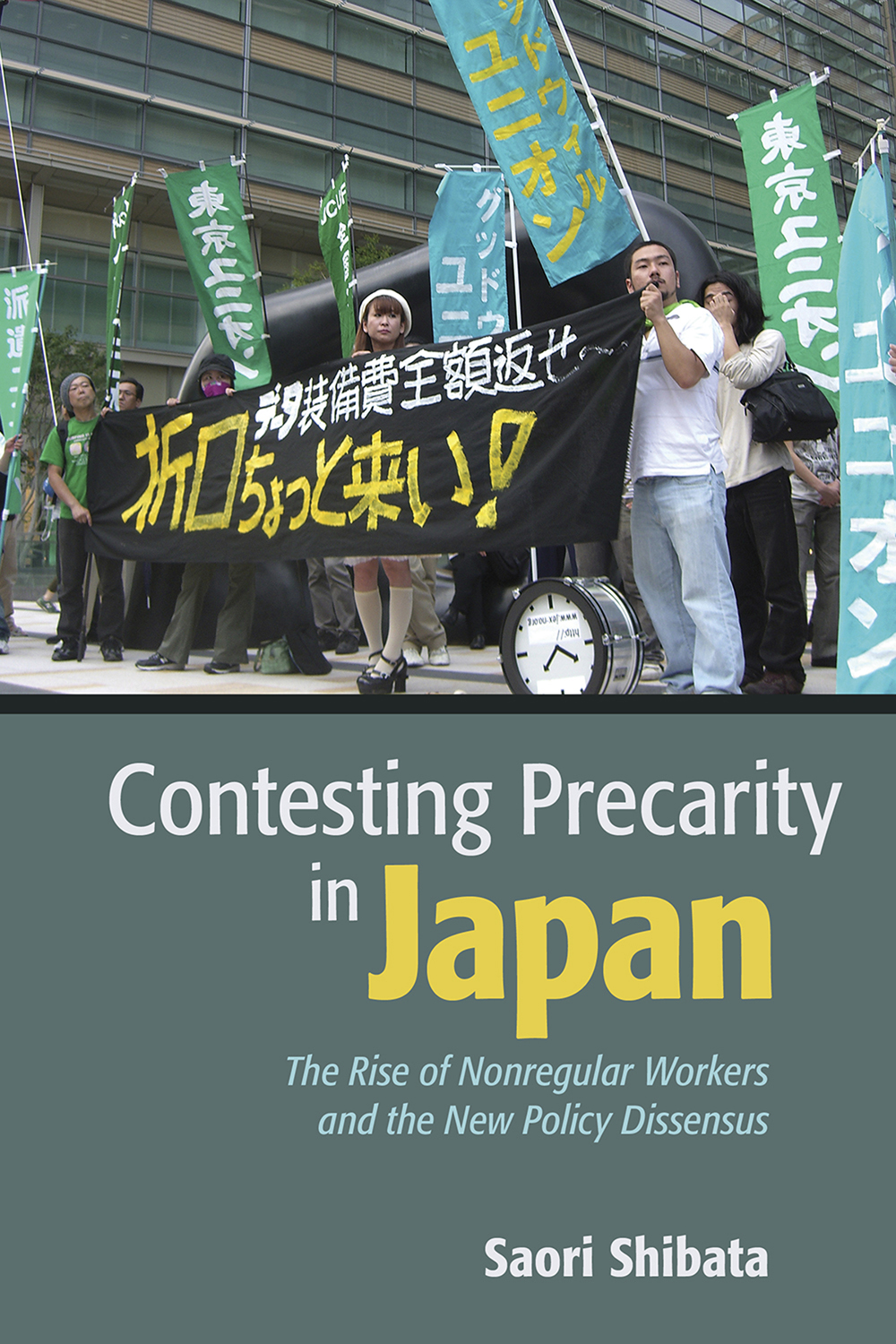
Contesting Precarity in Japan Contesting Precarity in Japan details the new forms of workers' protest and opposition that have developed as Japan's economy has transformed over the past three decades and highlights their impact upon the country's policymaking process. Drawing on a new dataset charting protest events from the 1980s to the present, Saori Shibata produces the first systematic study of Japan's new precarious labour movement. It details the movement's rise during Japan's post-bubble economic transformation and highlights the different and innovative forms of dissent that mark the end of the country's famously non-confrontational industrial relations. In doing so, moreover, she shows how this new pattern of industrial and social tension is reflected within the country's macroeconomic policymaking, resulting in a new policy dissensus that has consistently failed to offer policy reforms that would produce a return to economic growth. As a result, Shibata argues that the Japanese model of capitalism has therefore become increasingly disorganized. POLITICAL SCIENCE,Labor & Industrial Relations

Tell the Bosses We're Coming How labor union organizing can help leverage today's movements, and why workers need unions more than ever before Lengthening hours, lessening pay, no parental leave, scant job security… Never have so many workers needed so much support. Yet the very labor unions that could garner us protections and help us speak up for ourselves are growing weaker every day. In an age of rampant inequality, of increasing social protest and strikes – and when a majority of workers say they want to be union members – why does union density continue to decline? Shaun Richman offers some answers in his book, Tell the Bosses We're Coming. It’s time to bring unions back from the edge of institutional annihilation, says Richman. But that is no simple proposition. Richman explains how important it is that this book is published now, because the next few years offer a rare opportunity to undo the great damage wrought on labor by decades of corporate union-busting, if only union activists raise our ambitions. Based on deft historical research and legal analysis, as well as his own experience as a union organizing director, Richman lays out an action plan for U.S. workers in the twenty-first century by which we can internalize the concept that workers are equal human beings, entitled to health care, dignity, job security – and definitely, the right to strike. Unafraid to take on some of the labor movement’s sacred cows, this book describes what it would take – some changes that are within activists’ power and some that require meaningful legal reform – to put unions in workplaces across America. As Shaun Richman says, “I look forward to working with you.†POLITICAL SCIENCE,Labor & Industrial Relations

Worked Over An award-winning sociologist reveals the unexpected link between overwork and inequality. Most Americans work too long and too hard, while others lack consistency in their hours and schedules. Work hours declined for a century through hard-fought labor-movement victories, but they've increased significantly since the seventies. Worked Over traces the varied reasons why our lives became tethered to a new rhythm of work, and describes how we might gain a greater say over our labor time -- and build a more just society in the process. Popular discussions typically focus on overworked professionals. But as Jamie K. McCallum demonstrates, from Amazon warehouses to Rust Belt factories to California's gig economy, it's the hours of low-wage workers that are the most volatile and precarious -- and the most subject to crises. What's needed is not individual solutions but collective struggle, and throughout Worked Over McCallum recounts the inspiring stories of those battling today's capitalism to win back control of their time. POLITICAL SCIENCE,Labor & Industrial Relations
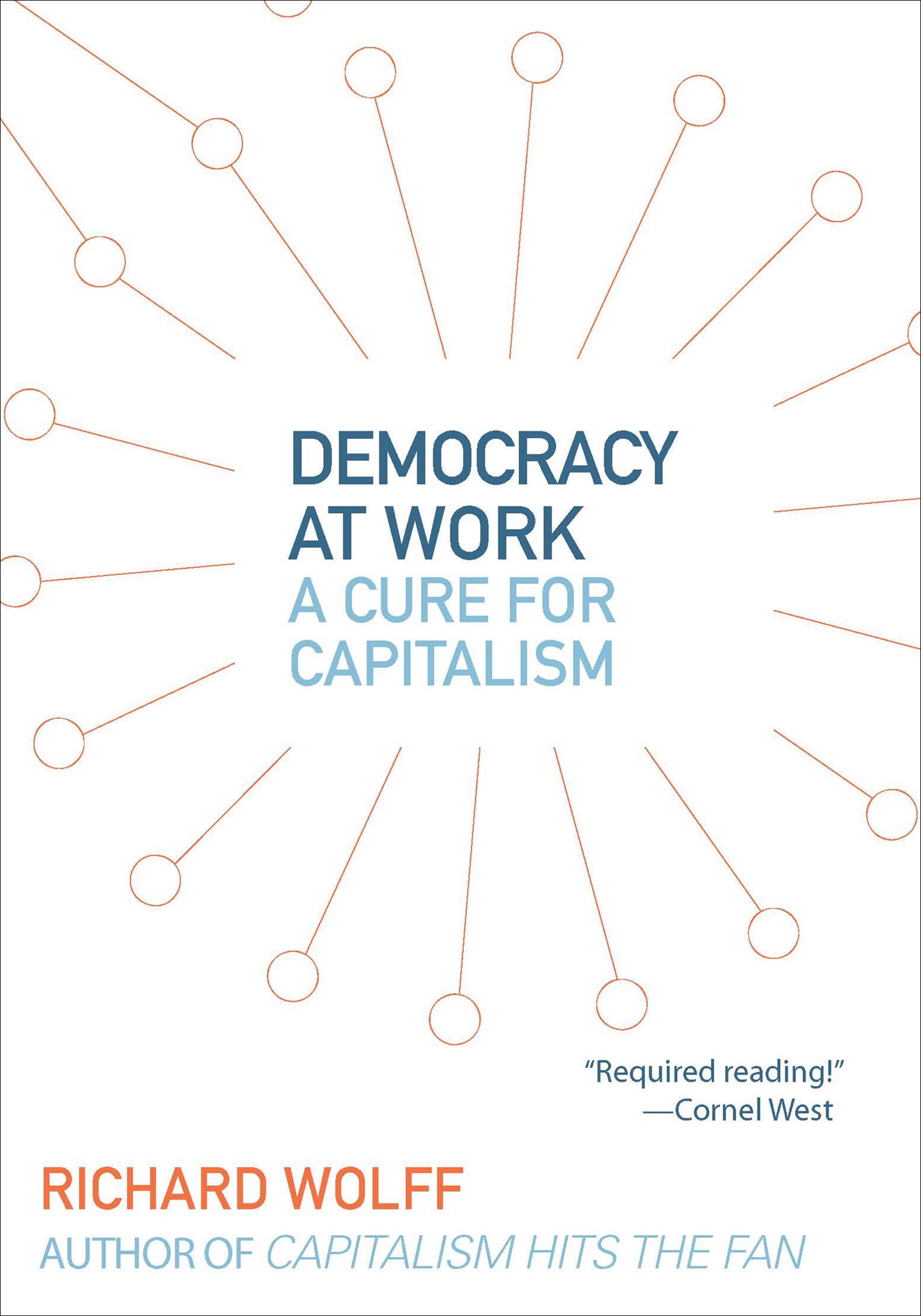
Democracy at Work What, and who, are we working for? A thoughtful assessment on our current society from “probably America’s most prominent Marxist economist†(The New York Times). Capitalism as a system has spawned deepening economic crisis alongside its bought-and-paid-for political establishment. Neither serves the needs of our society. Whether it is secure, well-paid, and meaningful jobs or a sustainable relationship with the natural environment that we depend on, our society is not delivering the results people need and deserve. One key cause for this intolerable state of affairs is the lack of genuine democracy in our economy as well as in our politics. The solution requires the institution of genuine economic democracy, starting with workers managing their own workplaces, as the basis for a genuine political democracy. Here Richard D. Wolff lays out a hopeful and concrete vision of how to make that possible, addressing the many people who have concluded economic inequality and politics as usual can no longer be tolerated and are looking for a concrete program of action. “Wolff’s constructive and innovative ideas suggest new and promising foundations for much more authentic democracy and sustainable and equitable development, ideas that can be implemented directly and carried forward. A very valuable contribution in troubled times.†—Noam Chomsky, leading public intellectual and author of Hope and Prospects POLITICAL SCIENCE,Labor & Industrial Relations

Kenny Riley and Black Union Labor Power in the Port of Charleston Their ancestors may have been cargo in the slave ships that arrived in Charleston, S.C. Today, the scale has been rebalanced: black longshoremen run the port's cargo operation. They are members of the International Longshoremen's Association, a powerful labor union, and Kenny Riley is the charismatic leader of the Charleston local. Riley combines commitment to the civil rights movement with the practicality to ensure that Charleston remains a principal East Coast port. He emerged on the international stage in 2000, rallying union members worldwide to the defense of "The Charleston Five," longshoremen arrested after a confrontation with police turned violent. This is Riley's story as well as a behind-the-scenes look at organized black labor in a Deep South port. POLITICAL SCIENCE,Labor & Industrial Relations

Between Fair and Rigged. Elections as a Key Determinant of the Borderline Political Regime - Turkey in Comparative Perspective At the beginning of the 21st century, there are an increasing number of states in which elections do not meet the standards of liberal democracy due to electoral malpractices. The analysis of the malpractices at all stages of the electoral cycle and their impact on the political regime is the primary objective of this book. The research focuses on Turkey. However, the authors move one step further and try to present the Turkish case from a comparative perspective. They analyse selected countries in Central Europe, the Balkans and Latin America. They investigate an interesting process of mutual reinforcement of increasingly serious electoral malpractices and change in/of the political regime. It leads to the development of ‘borderline regimes’ balancing between two types of political regimes. POLITICAL SCIENCE,Labor & Industrial Relations
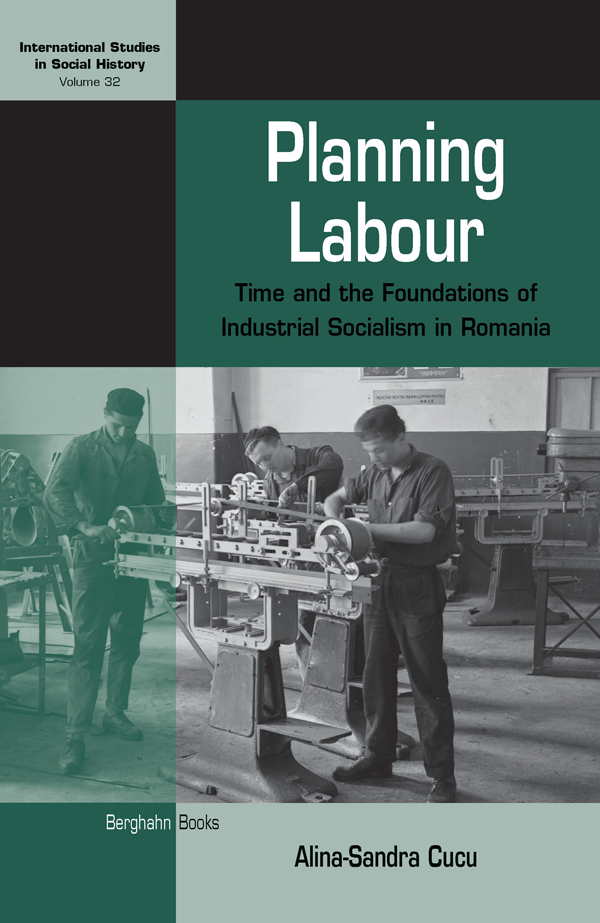
Planning Labour Impoverished, indebted, and underdeveloped at the close of World War II, Romania underwent dramatic changes as part of its transition to a centrally planned economy. As with the Soviet experience, it pursued a policy of “primitive socialist accumulation†whereby the state appropriated agricultural surplus and restricted workers’ consumption in support of industrial growth. Focusing on the daily operations of planning in the ethnically mixed city of Cluj from 1945 to 1955, this book argues that socialist accumulation was deeply contradictory: it not only inherited some of the classical tensions of capital accumulation, but also generated its own, which derived from the multivocal nature of the state socialist worker as a creator of value, as living labour, and as a subject of emancipatory politics. POLITICAL SCIENCE,Labor & Industrial Relations

The Corrosion of Character A Business Week Best Book of the Year.... "A devastating and wholly necessary book."—Studs Terkel, author of Working In The Corrosion of Character, Richard Sennett, "among the country's most distinguished thinkers . . . has concentrated into 176 pages a profoundly affecting argument" (Business Week) that draws on interviews with dismissed IBM executives, bakers, a bartender turned advertising executive, and many others to call into question the terms of our new economy. In his 1972 classic, The Hidden Injuries of Class (written with Jonathan Cobb), Sennett interviewed a man he called Enrico, a hardworking janitor whose life was structured by a union pay schedule and given meaning by his sacrifices for the future. In this new book-a #1 bestseller in Germany-Sennett explores the contemporary scene characterized by Enrico's son, Rico, whose life is more materially successful, yet whose work lacks long-term commitments or loyalties. Distinguished by Sennett's "combination of broad historical and literary learning and a reporter's willingness to walk into a store or factory [and] strike up a conversation" (New York Times Book Review), this book "challenges the reader to decide whether the flexibility of modern capitalism . . . is merely a fresh form of oppression" (Publishers Weekly, starred review). Praise for The Corrosion of Character: "A benchmark for our time."—Daniel Bell "[A]n incredibly insightful book."—William Julius Wilson "[A] remarkable synthesis of acute empirical observation and serious moral reflection."—Richard Rorty "[Sennett] offers abundant fresh insights . . . illuminated by his concern with people's struggle to give meaning to their lives."—[Memphis] Commercial Appeal POLITICAL SCIENCE,Labor & Industrial Relations

The SAGE Dictionary of Policing The SAGE Dictionary of Policing is THE definitive reference tool for students and academics in Police Studies. POLITICAL SCIENCE,Law Enforcement

Lessons of Criminology Presents the stories, musings, advice and conclusions of well-known criminologists about their research and their careers. Provides readers with suggestions about how to manage their professional lives. Contributors include Frank Cullen, Julius Debro, Don Gibbons, John Irwin, Mac Klein, Gary Marx, Joan McCord, Richard Quinney, Frank Scarpitti, Jim Short, Rita Simon, Charles Tuttle and Jackson Toby. POLITICAL SCIENCE,Law Enforcement

Cybercrime This innovative text provides an excellent introduction to technology-assisted crime and the basics of investigating such crime, from the criminal justice perspective. It presents clear, concise explanations for students and professionals, who need not be technically proficient to find the material easy-to-understand and practical. The book begins by identifying and defining the most prevalent and emerging high-technology crimes — and exploring their history, their original methods of commission, and their current methods of commission. Then it delineates the requisite procedural issues associated with investigating technology-assisted crime. In addition, the text provides a basic introduction to computer forensics, explores legal issues in the admission of digital evidence, and then examines the future of high-technology crime, including legal responses. POLITICAL SCIENCE,Law Enforcement

Experiencing Corrections Written by scholars who have practical experience in corrections, the readable essays in this one-of-a-kind collection draw on real-world experiences to illustrate theoretical and methodological concepts and demonstrate approaches to corrections practice. Spanning the three general types of correctional environments—incarceration, community corrections, and juvenile corrections—the essays discuss working in prisons or prison systems, juvenile residential and community corrections, and probation and parole. POLITICAL SCIENCE,Law Enforcement

Criminal Justice Policy and Planning Unlike other textbooks on the subject, Criminal Justice Policy and Planning: Planned Change, Fifth Edition, presents a comprehensive and structured account of the process of administering planned change in the criminal justice system. Welsh and Harris detail a simple yet sophisticated seven-stage model, which offers students and practitioners a full account of program and policy development from beginning to end. The authors thoughtfully discuss the steps: analyzing a problem; setting goals and objectives; designing the program or policy; action planning; implementing and monitoring; evaluating outcomes; and reassessing and reviewing. Within these steps, students focus on performing essential procedures, such as conducting a systems analysis, specifying an impact model, identifying target populations, making cost projections, collecting monitoring data, and performing evaluations. In reviewing these steps and procedures, students can develop a full appreciation for the challenges inherent in the process and understand the tools that they require to meet those challenges. To provide for a greater understanding of the material, the text uses a wide array of real-life case studies and examples of programs and policies. Examples include policies such as Restorative Justice, Justice Reinvestment, Stop-and-Frisk, and the Brady Act, and programs such as drug courts, community-based violence prevention, and halfway houses. By examining the successes and failures of various innovations, the authors demonstrate both the ability of rational planning to make successful improvements and the tendency of unplanned change to result in undesirable outcomes. The result is a powerful argument for the use of logic, deliberation, and collaboration in criminal justice innovations. POLITICAL SCIENCE,Law Enforcement
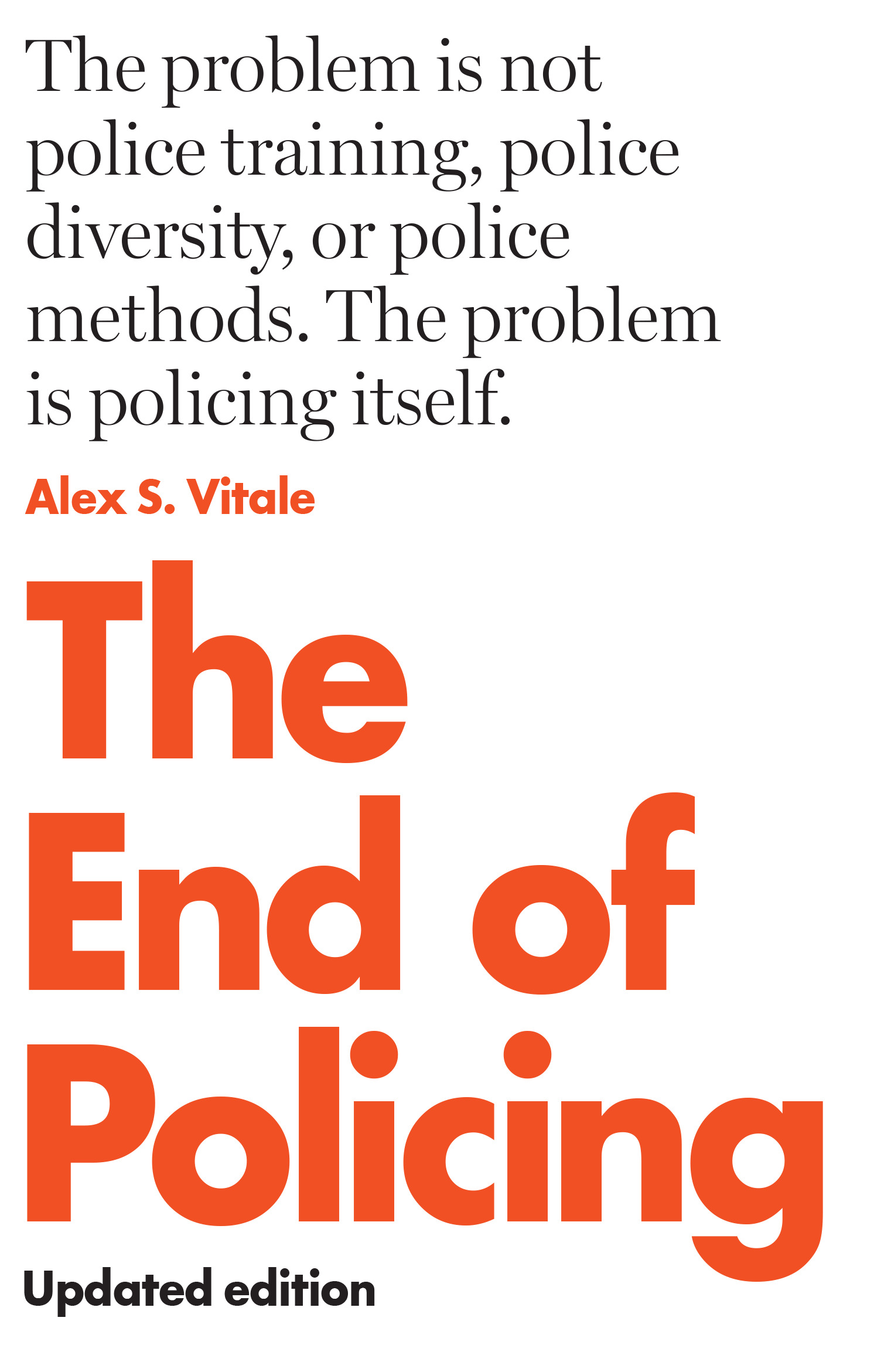
The End of Policing LOS ANGELES TIMES BESTSELLER The problem is not overpolicing, it is policing itself. Why we need to defund the police and how we get there. Recent weeks have seen an explosion of protest against police brutality and repression. Among activists, journalists and politicians, the conversation about how to respond and improve policing has focused on accountability, diversity, training, and community relations. Unfortunately, these reforms will not produce results, either alone or in combination. The core of the problem must be addressed: the nature of modern policing itself. This book attempts to spark public discussion by revealing the tainted origins of modern policing as a tool of social control. It shows how the expansion of police authority is inconsistent with community empowerment, social justice— even public safety. Drawing on groundbreaking research from across the world, and covering virtually every area in the increasingly broad range of police work, Alex Vitale demonstrates how law enforcement has come to exacerbate the very problems it is supposed to solve. In contrast, there are places where the robust implementation of policing alternatives—such as legalization, restorative justice, and harm reduction—has led to a decrease in crime, spending, and injustice. The best solution to bad policing may be an end to policing. POLITICAL SCIENCE,Law Enforcement
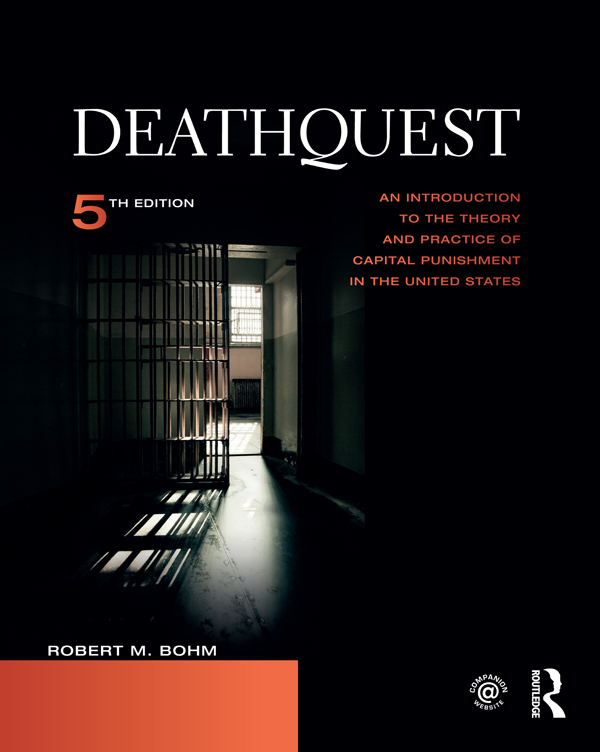
DeathQuest This fifth edition of the first true textbook on the death penalty engages the reader with a full account of the arguments and issues surrounding capital punishment. The book begins with the history of the death penalty from colonial to modern times, and then examines the moral and legal arguments for and against capital punishment. It also provides an overview of major Supreme Court decisions and describes the legal process behind the death penalty. In addressing these issues, the author reviews recent developments in death penalty law and procedure, including ramifications of newer case law, such as that regarding using lethal injection as a method of execution. The author’s motivation has been to understand what motivates the "deathquest" of the American people, leading a large percentage of the public to support the death penalty. The book educates readers so that whatever their death penalty positions are, they are informed opinions. POLITICAL SCIENCE,Law Enforcement

The Everything Private Investigation Book Observe someone without being observed. Dig up long-buried dirt. Catch a cheating spouse. The Everything Private Investigation Book shows you the basic research techniques and tricks the pros use. You'll learn how to get background information using a wide range of sources, including newspapers, court records, military files, and even the DMV. Written by experienced investigators, this guide helps you to: Use the Internet to get information on anyone and anything Conduct background checks for prospective employees or tenants Uncover hidden identities and assets Manage a physical or electronic surveillance Protect privacy and avoid identity theft Whether you're a journalist, an amateur genealogist, a business owner, a landlord, or just curious, you'll find essential information in this guide. In addition to being a valuable resource, The Everything Private Investigation Book is also a fascinating read. Even "armchair detectives" will enjoy reading about famous real-life and fictional PIs and the little-known secrets professionals use to crack the case. Sheila L. Stephens was the first female Alcohol, Tobacco & Firearms (ATF) special agent in the state of Alabama and one of the first in the nation. She recently graduated from Boston University with a master's degree in criminal justice. After leaving the ATF due to injury, Ms. Stephens opened a private investigation/security business. She is a criminal justice professor at Andrew Jackson University and a contributing writer and associate editor of The Agent, the newsletter of the National Association of Federal Agents (NAFA). Ms. Stephens lives in Bessemer, AL. POLITICAL SCIENCE,Law Enforcement

To Protect and Serve The police in America belong to the people -- not the other way around. Yet millions of Americans experience their cops as racist, brutal, and trigger-happy: an overly aggressive, militarized enemy of the people. For their part, today's officers feel they are under siege -- misunderstood, unfairly criticized, and scapegoated for society's ills. Is there a fix? Former Seattle Police Chief Norm Stamper believes there is. Policing is in crisis. The last decade has witnessed a vast increase in police aggression, misconduct, and militarization, along with a corresponding reduction in transparency and accountability. It is not just noticeable in African American and other minority communities -- where there have been a series of high-profile tragedies -- but in towns and cities across the country. Racism -- from raw, individualized versions to insidious systemic examples -- appears to be on the rise in our police departments. Overall, our police officers have grown more and more alienated from the people they've been hired to serve. In To Protect and Serve, Stamper delivers a revolutionary new model for American law enforcement: the community-based police department. It calls for fundamental changes in the federal government's role in local policing as well as citizen participation in all aspects of police operations: policymaking, program development, crime fighting and service delivery, entry-level and ongoing education and training, oversight of police conduct, and -- especially relevant to today's challenges -- joint community-police crisis management. Nothing will ever change until the system itself is radically restructured, and here Stamper shows us how. POLITICAL SCIENCE,Law Enforcement
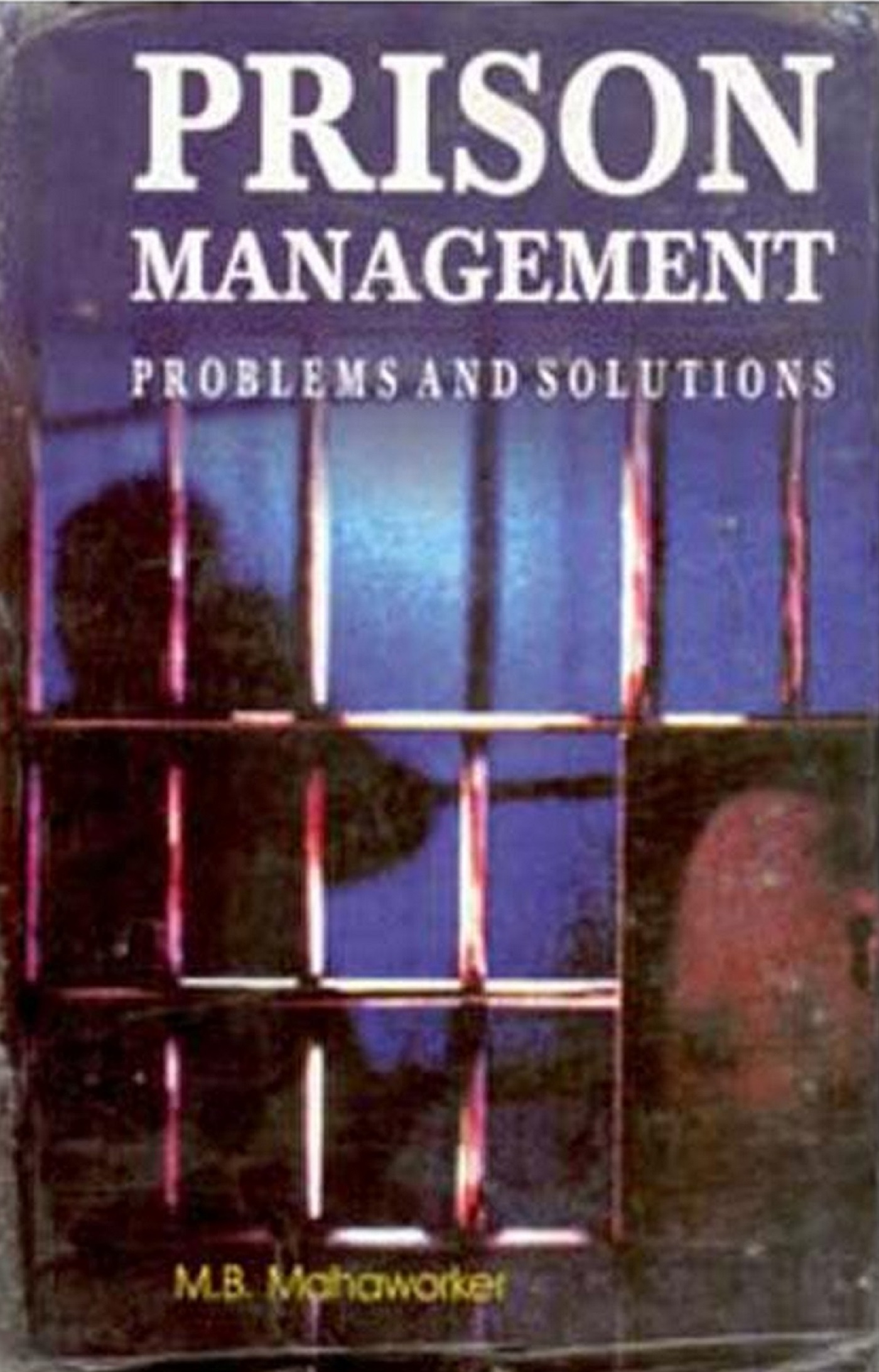
Prison Management The aims and objectives of this research work is to develop a global movement to replace the institution of prison by alternatives to prison and imprisonment. The book is dealt with in eight chapters—Origin of prison and objectives of study, prison administration in General, Reformation of the poison system in India, prison administration in independent India, prison management in Karnataka, international contemporary scene, the future of prison in India etc. A useful book for policy makers and administrators.\ POLITICAL SCIENCE,Law Enforcement

The Black and the Blue During his 28-year career, Matthew Horace rose through the ranks from a police officer working the beat to a federal agent working criminal cases in some of the toughest communities in America to a highly decorated federal law enforcement executive managing high-profile investigations nationwide. Yet it was not until seven years into his service- when Horace found himself face down on the ground with a gun pointed at his head by a white fellow officer-that he fully understood the racism seething within America's police departments. Through gut-wrenching reportage, on-the-ground research, and personal accounts from interviews with police and government officials around the country, Horace presents an insider's examination of archaic police tactics. He dissects some of the nation's most highly publicized police shootings and communities to explain how these systems and tactics have hurt the people they serve, revealing the mistakes that have stoked racist policing, sky-high incarceration rates, and an epidemic of violence. "Horace's authority as an experienced officer, as well as his obvious integrity and courage, provides the book with a gravitas." -- The Washington Post "The Black and the Blue is an affirmation of the critical need for criminal justice reform, all the more urgent because it comes from an insider who respects his profession yet is willing to reveal its flaws." -- USA Today POLITICAL SCIENCE,Law Enforcement

American Prison An enraging, necessary look at the private prison system, and a convincing clarion call for prison reform.” —NPR.org New York Times Book Review 10 Best Books of 2018 * One of President Barack Obama’s favorite books of 2018 * Winner of the 2019 J. Anthony Lukas Book Prize * Winner of the Helen Bernstein Book Award for Excellence in Journalism * Winner of the 2019 RFK Book and Journalism Award * A New York Times Notable Book A ground-breaking and brave inside reckoning with the nexus of prison and profit in America: in one Louisiana prison and over the course of our country's history. In 2014, Shane Bauer was hired for $9 an hour to work as an entry-level prison guard at a private prison in Winnfield, Louisiana. An award-winning investigative journalist, he used his real name; there was no meaningful background check. Four months later, his employment came to an abrupt end. But he had seen enough, and in short order he wrote an exposé about his experiences that won a National Magazine Award and became the most-read feature in the history of the magazine Mother Jones. Still, there was much more that he needed to say. In American Prison, Bauer weaves a much deeper reckoning with his experiences together with a thoroughly researched history of for-profit prisons in America from their origins in the decades before the Civil War. For, as he soon realized, we can't understand the cruelty of our current system and its place in the larger story of mass incarceration without understanding where it came from. Private prisons became entrenched in the South as part of a systemic effort to keep the African-American labor force in place in the aftermath of slavery, and the echoes of these shameful origins are with us still. The private prison system is deliberately unaccountable to public scrutiny. Private prisons are not incentivized to tend to the health of their inmates, or to feed them well, or to attract and retain a highly-trained prison staff. Though Bauer befriends some of his colleagues and sympathizes with their plight, the chronic dysfunction of their lives only adds to the prison's sense of chaos. To his horror, Bauer finds himself becoming crueler and more aggressive the longer he works in the prison, and he is far from alone. A blistering indictment of the private prison system, and the powerful forces that drive it, American Prison is a necessary human document about the true face of justice in America. POLITICAL SCIENCE,Law Enforcement

Handcuffed Whatever happened to community and problem-oriented policing? How the current crisis in policing can be traced to failures of reform. The police shooting of an unarmed young black man in the St. Louis suburb of Ferguson, Missouri, in August 2014 sparked riots and the beginning of a national conversation on race and policing. Much of the ensuing discussion has focused on the persistence of racial disparities and the extraordinarily high rate at which American police kill civilians (an average of roughly three per day). Malcolm Sparrow, who teaches at Harvard’s Kennedy School and is a former British police detective, argues that other factors in the development of police theory and practice over the last twenty-five years have also played a major role in contributing to these tragedies and to a great many other cases involving excessive police force and community alienation. Sparrow shows how the core ideas of community and problem-solving policing have failed to thrive. In many police departments these foundational ideas have been reduced to mere rhetoric. The result is heavy reliance on narrow quantitative metrics, where police define how well they are doing by tallying up traffic tickets issued (Ferguson), or arrests made for petty crimes (in New York). Sparrow’s analysis shows what it will take for police departments to escape their narrow focus and perverse metrics and turn back to making public safety and public cooperation their primary goals. Police, according to Sparrow, are in the risk-control business and need to grasp the fundamental nature of that challenge and develop a much more sophisticated understanding of its implications for mission, methods, measurement, partnerships, and analysis. POLITICAL SCIENCE,Law Enforcement
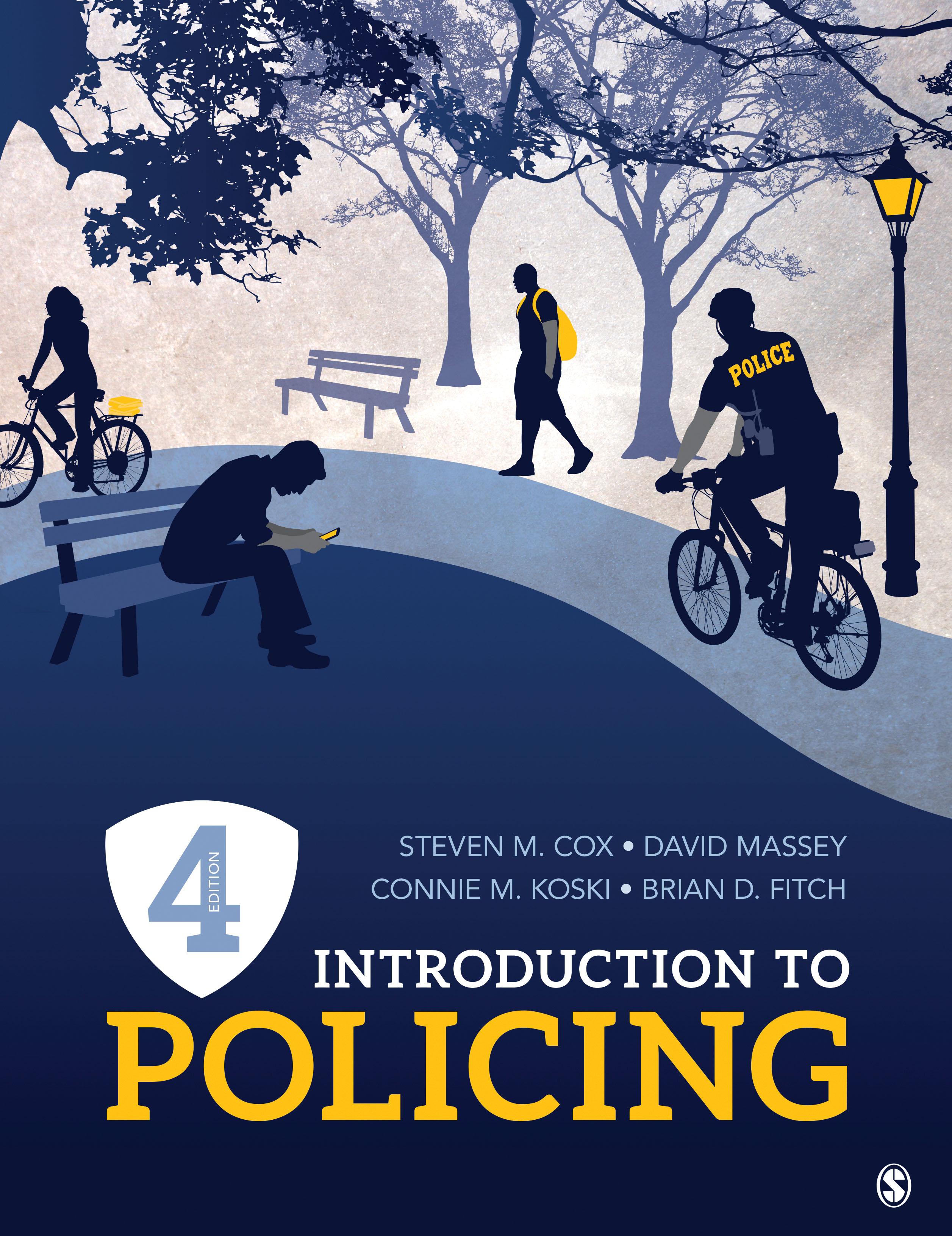
Introduction to Policing Written and extensively updated by an author team that includes former and current law enforcement officers, Introduction to Policing focuses on the thought-provoking, contemporary issues that underscore the challenging and rewarding world of policing. The authors skillfully balance research and practice to offer readers an overview of both the foundations of policing and the expanded role of today’s police officers. Evolving with the modern realities of the field, the Fourth Edition discusses major new and ongoing impactful events, such as the political shift marked by the U.S. presidential election of 2016 and expanded coverage of women and minorities in policing. The accessible and engaging writing style, coupled with unique coverage of the issues of policing in multicultural communities, the impact of technology on policing, and policing strategies and procedures, make this bestselling book a must-have. POLITICAL SCIENCE,Law Enforcement

Exonerated As seen on The Ben Shapiro Show! A NEW YORK TIMES BESTSELLER “Great new book by wonderful and very street smart author Dan Bongino, EXONERATED, THE FAILED TAKEDOWN OF PRESIDENT DONALD TRUMP BY THE SWAMP. Dan hits all of the crooked points of the greatest Witch Hunt in political history. Nevertheless, the Scam continues!†—President Donald J. Trump An explosive, whistle-blowing expose, Exonerated: The Failed Takedown of Donald Trump by the Swamp reveals how Deep State actors relied on a cynical plug-and-play template to manufacture the now-discredited Russiagate scandal. With the cutting analysis and insight he exhibited in his blockbuster bestseller Spygate: The Attempted Sabotage of Donald J. Trump, Fox News contributor Bongino exposes who masterminded the dangerous playbook to take down Trump, their motives, and how a plan filled with faked allegations backfired—forcing investigators to up the ante and hide their missteps and half-truths in a desperate effort to prove a collusion case that never happened. The result? The misguided multimillion Mueller investigation that tore the nation apart, tried to destabilize the presidency and led, as the world now knows, to nowhere! POLITICAL SCIENCE,Law Enforcement
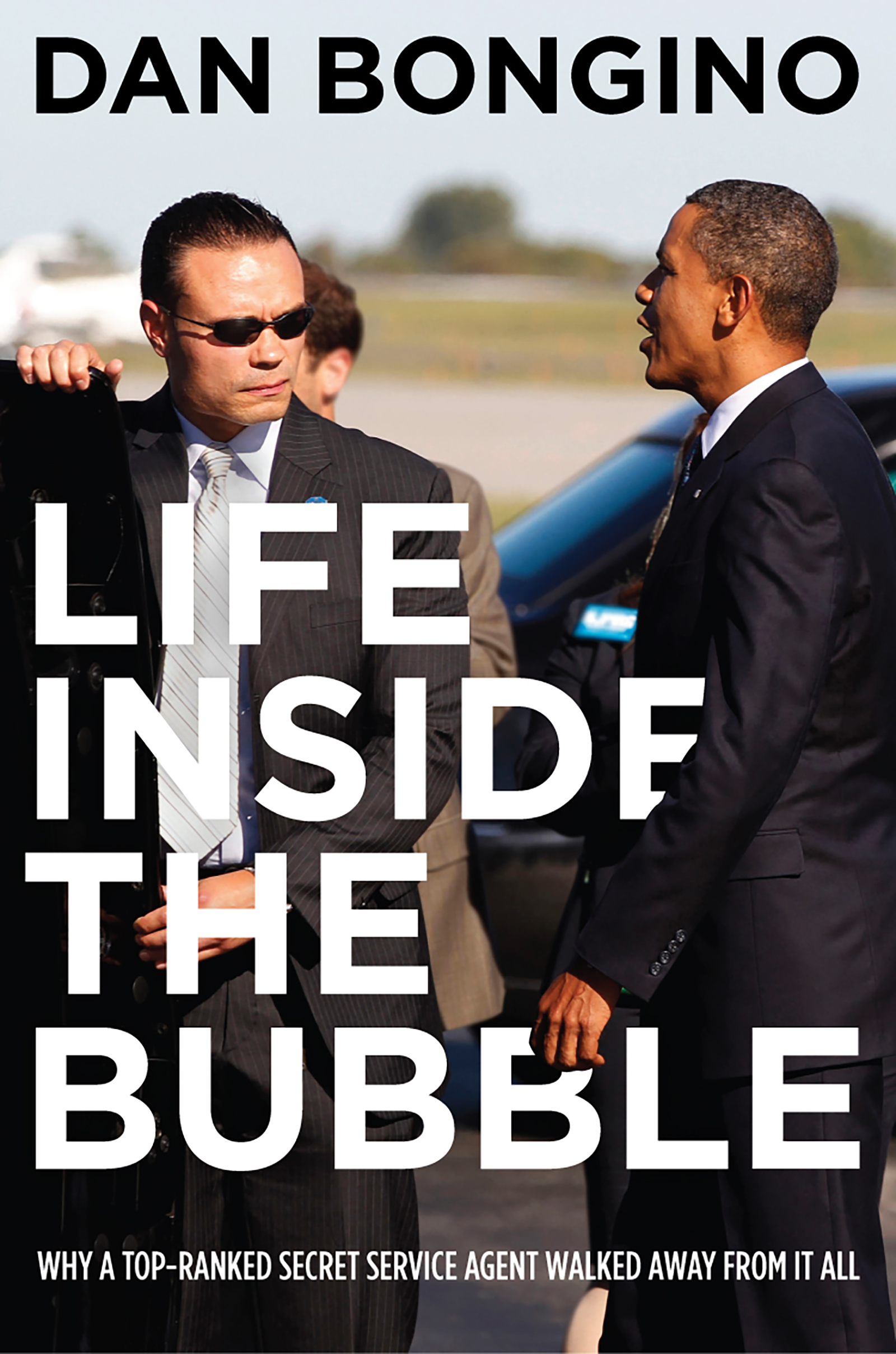
Life Inside the Bubble "He swore to take a bullet for the President and left it all behind to take a bullet for the American people" Why would a successful, twelve-year Secret Service agent resign his position in the prime of his career to run for political office against all the odds? New York Times bestseller, Life Inside the Bubble is an intimate look at life inside the presidential “bubble,†a haze of staffers, consultants, cronies, acolytes, bureaucrats and lobbyists that creates the “alternate reality†in which monumental policy decisions are made. And it is the story of a dedicated Secret Service professional who, after years inside the “bubble,†walked away in favor of sounding a clarion call to the American people in defense of sane government and the US Constitution. Finally, why the Fast & Furious scandal, the bombings in Boston and the terrorist attacks in Benghazi are harbingers of what’s to come without a bold change in direction. POLITICAL SCIENCE,Law Enforcement
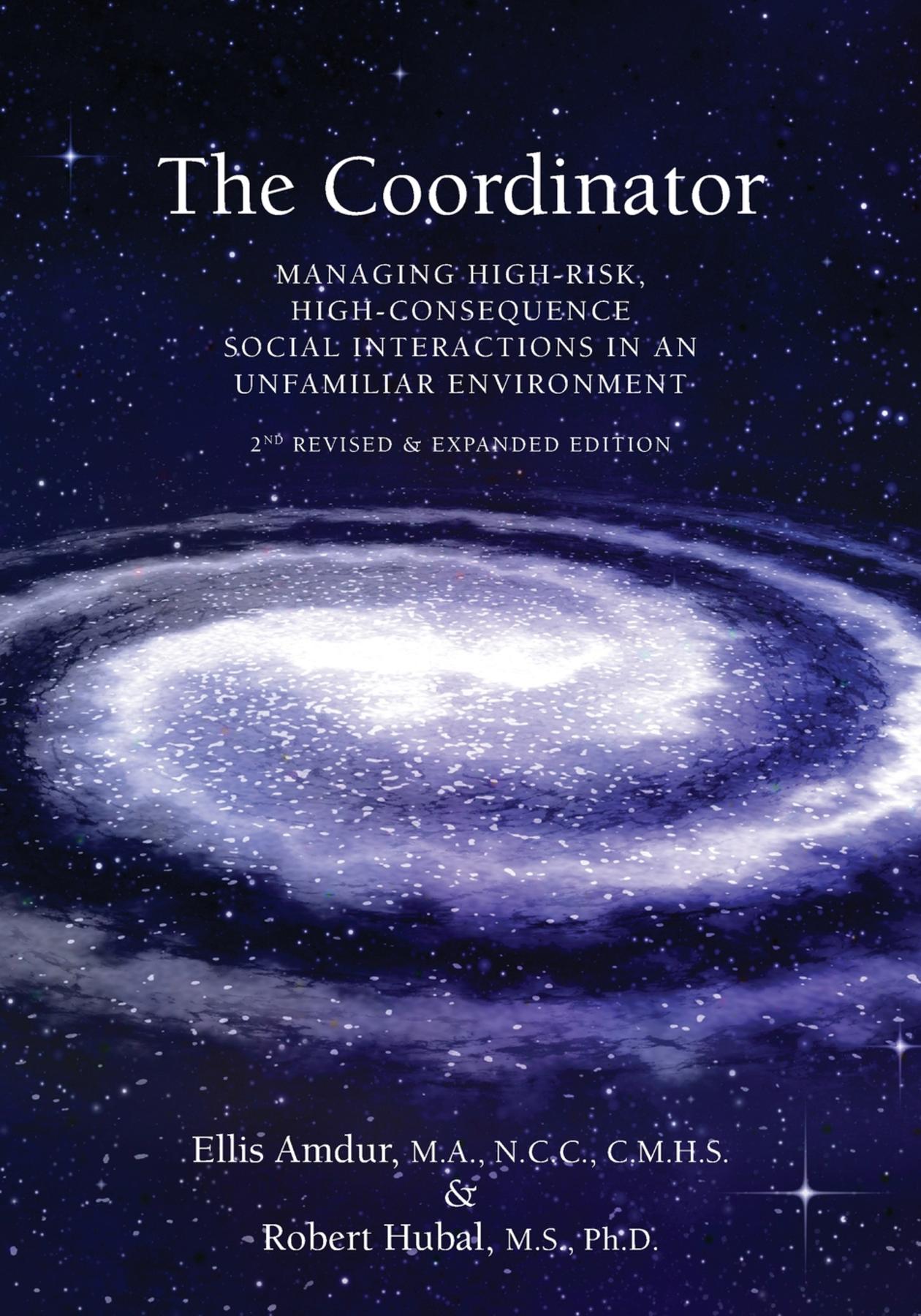
The Coordinator How should a law enforcement officer manage an encounter with someone who might be mentally unstable or in crisis—but does not appear to pose an immediate threat? How might a platoon commander engage with a foreign civilian who has key information for an intelligence-gathering mission, but is wary of sharing—maybe even being seen—with a stranger? In both cases, how does that officer remain prepared for something going terribly wrong at any moment, while still maintaining the intention and ability to help? What common skills do these scenarios—and many others like them—require? In The Coordinator, Ellis Amdur and Robert Hubal share their decades of experience working with law enforcement and military personnel in training and developing social interaction skills, particularly in ‘high risk, high consequence’ situations with individuals who may always view themselves as adversaries. The Coordinator is someone who is always trying to reach an accord with the other person, striving to establish community liaison, rapport, crisis management, and deescalation of aggression. The Coordinator maintains a focus on tactics, doing everything possible to enhance the safety of all people involved in the encounter. Simultaneously, the Coordinator strives to achieve a level of trust, engaging others with professionalism and respect. The Coordinator crafts the communication to form a working relationship to share in achieving the aims of the mission. “I have known Robert Hubal for many years, starting as a colleague at RTI International, and continuing to other training and educational efforts involving military and law enforcement. The Coordinator, a result of his collaboration with Ellis Amdur, offers a clear approach to confrontations with adversarial, potentially dangerous individuals. This ‘Coordinator Mindset’ focuses everyone involved on both the problems and resolution of an incident. From my over 40 years of service in the military and then in law enforcement, as well as my studies on interviewing and effective methods for training interviewing skills, I see these skills as valuable in military personnel at various levels as well as in the law enforcement and intelligence areas. This is a great book to have around to aid in achieving the best solution possible, while lowering the risk of the encounter turning violent, without compromising the military or law enforcement mission that brought one into the situation.†– Dr. Don Gemeinhardt (Col. USAF Retired) POLITICAL SCIENCE,Law Enforcement
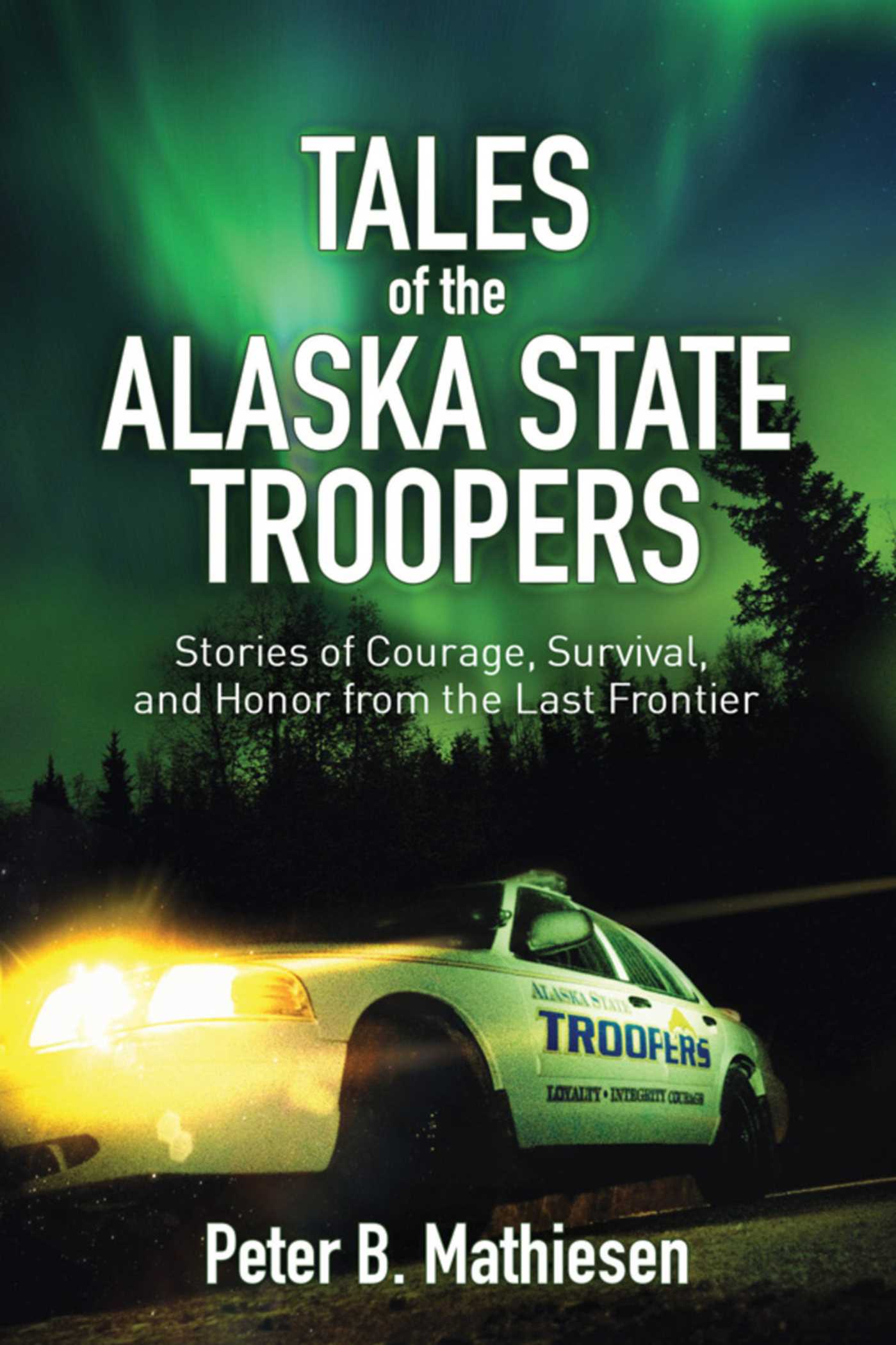
Tales of the Alaska State Troopers With the elements against them, the state troopers of Alaska face every day with a fight for their lives. In the state of Alaska, anything goes. For the state troopers, an average day can include blizzard conditions, midnight sunsets, and subzero temperatures. Tales of the Alaska State Troopers gives insight to just how the brave men and women of the law combat these conditions while still upholding their duties to the fine people of Alaska. Follow trooper Dan Valentine as he finds himself in the midst of a crisis when an abandoned truck holds more than just an old blanket on the passenger seat. Dan’s responsibility for the town of Trapper Creek becomes a fight for survival when he realizes the truck has enough explosives in it to make a small dent in the Alaska Range. With his fellow lawmen, Valentine not only must handle the situation, but he must also make sure that the citizens of Trapper Creek are evacuated from harm’s way. Tales of the Alaska State Troopers is rich in content and action. Anyone familiar with the life of a lawman or the state of Alaska will be fascinated with the way Mathiesen delivers his narrative. It’s all in a day’s work for troopers like Dan Valentine, who never know what a new day can bring. POLITICAL SCIENCE,Law Enforcement

Policing Ferguson, Policing America Following the fatal shooting in broad daylight of unarmed African American Michael Brown by a white cop in August 2014, Ferguson, Missouri became the scene of protests that pitted law enforcement against locals and Black Lives matter activists. The media firestorm has not waned, and, in fact, has grown stronger in light of all the recent violence by and against police officers nationwide. According to Ferguson’s former police chief Tom Jackson, the uninformed media actually fans the flames of unrest and exploits the situation: infotainment optics have become more important than truth, while social media spreads the news without providing context. Policing Ferguson, Policing America is the book that finally tells the inside story of what happened in Ferguson, and how good guys became the bad guys through media and political distortion. Pressure is at a boiling point. In 2016, America has been rocked by heart-wrenching fatal shootings of African Americans by police officers in Louisiana and in Minnesota, and by the shootings of police offers in Dallas, Baton Rouge, and Kansas City that left eleven officers dead and a dozen more wounded. To many Americans, the central theme of this continuing bloody story is one of racial injustice and out-of-control policing. Policing Ferguson, Policing America brings common sense and a keen insider’s understanding to a complex story. Black Lives Matter, and so do the lives of cops. Citizens and law-enforcement professionals alike feel the urgent need for our systems and procedures to change for the better. Few people are in a better position to explore the issues than Chief Jackson. In Policing Ferguson, Policing America, Jackson tells for the first time the real Ferguson story while sharing his thoughts about the steps we can take together to improve all Americans’ lives, and restore the vital trust between the police and the communities they serve. His well-informed recommendations just may improve this dire situation. POLITICAL SCIENCE,Law Enforcement

Police Brutality A landmark work by twelve leading critics and community leaders—essential reading for anyone interested in the history of American race relations. Ignited by the infamous shooting of Amadou Diallo, unarmed and innocent, at the hands of New York City police officers, journalist Jill Nelson was moved to assemble this landmark anthology on the topic of police violence and brutality: an indispensable collection of twelve "groundbreaking" (Ebony) essays by a range of contributors—among them academics, historians, social critics, a congressman, and an ex-New York City police detective. This "important and valuable book" (Emerge) places a centuries-old issue in much-needed historical and intellectual context, and underscores the profound influence police brutality has had in shaping the American identity. "[S]hould be read by anyone concerned about ending brutality, and should be required reading in police academies throughout America!"—Charles J. Ogletree, Jr., Harvard Law School "Without hysteria or hyperbole, [Nelson] examines the issue of police abuse in literary form."—Emerge "A memorable and useful contribution to an increasingly volatile national dialogue."—Publishers Weekly "[N]ot only timely, but explores and exposes the sickness of this unbalanced, uncivilized Western pastime thoroughly."—Chuck D of Public Enemy, author of Fight the Power: Rap, Race, and Reality POLITICAL SCIENCE,Law Enforcement
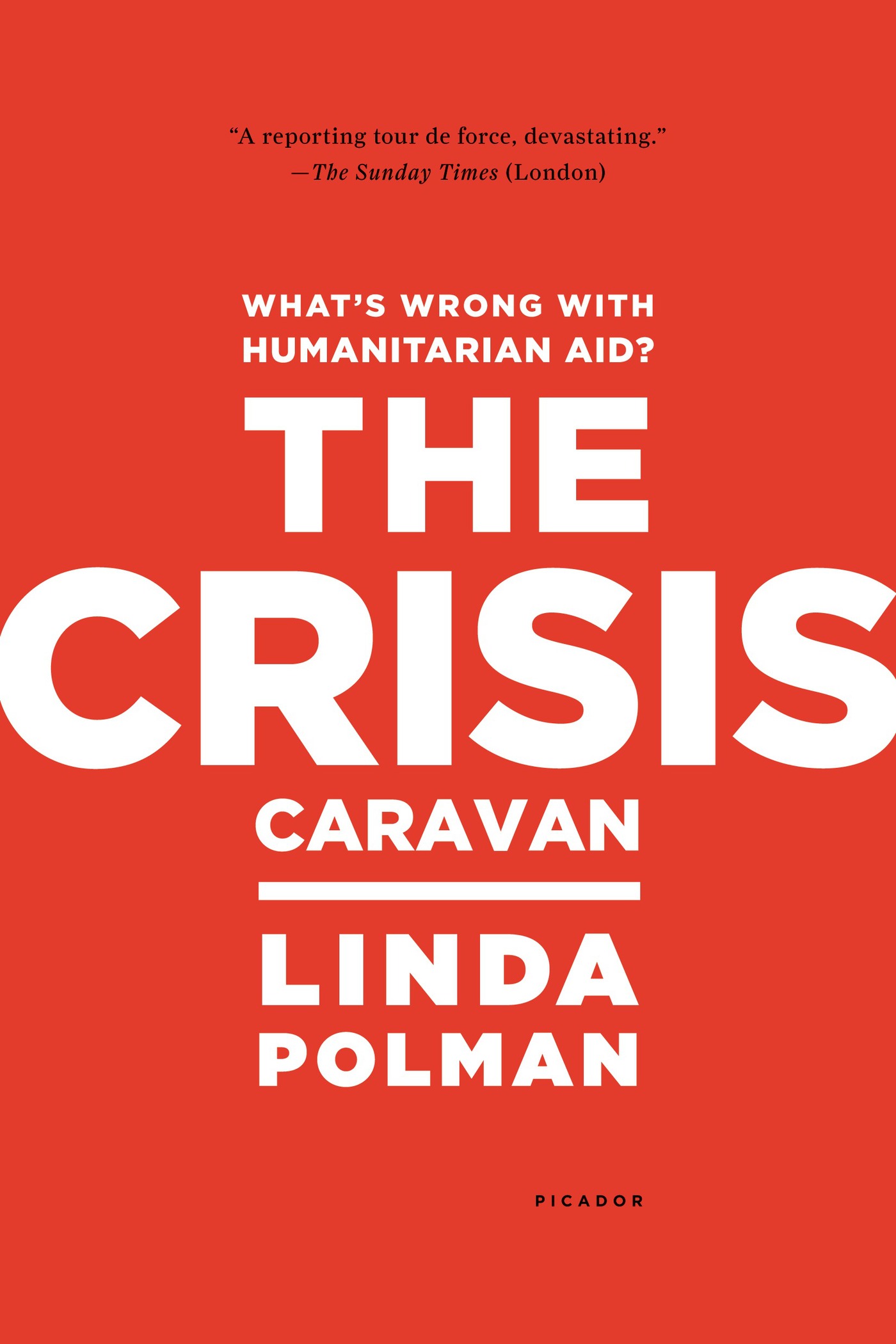
The Crisis Caravan A no-holds-barred, controversial exposé of the financial profiteering and ambiguous ethics that pervade the world of humanitarian aid A vast industry has grown up around humanitarian aid: a cavalcade of organizations—some 37,000—compete for a share of the $160 billion annual prize, with "fact-inflation" sometimes ramping up disaster coverage to draw in more funds. Insurgents and warring governments, meanwhile, have made aid a permanent feature of military strategy: refugee camps serve as base camps for genocidaires, and aid supplies are diverted to feed the troops. Even as humanitarian groups continue to assert the holy principle of impartiality, they have increasingly become participants in aid's abuses. In a narrative that is impassioned, gripping, and even darkly absurd, journalist Linda Polman takes us to war zones around the globe—from the NGO-dense operations in "Afghaniscam" to the floating clinics of Texas Mercy Ships proselytizing off the shores of West Africa—to show the often compromised results of aid workers' best intentions. It is time, Polman argues, to impose ethical boundaries, to question whether doing something is always better than doing nothing, and to hold humanitarians responsible for the consequences of their deeds. POLITICAL SCIENCE,NGOs (Non-Governmental Organizations)

Theories and Practices of Development Global economic crisis and the implications of global environmental change have led academics and policy-makers to consider how ‘development’ in all parts of the world should be achieved. However, ‘development’ has always been a contested idea. While often presented as a positive process to improve people’s lives, the potential negative dimensions of ‘development’ on people and environments must also be recognized. Theories and Practices of Development provides a clear and user-friendly introduction to the complex debates around how development has been understood and achieved. The second edition has been fully updated and expanded to reflect global political and economic shifts, as well as new approaches to development. The rise of China and India is given particular attention, as is the global economic crisis and its implications for development theories and practice. There are new sections on faith-based development, and the development dimensions of climate change, as well as greater engagement with development theories as they are put into practice in the Global North. The book deals with the evolution of development ideas and policies, focusing on economic, political, social, environmental and spatial dimensions. It highlights how development cannot be considered as a neutral concept, but is entwined with inequalities in power at local, as well as national and global scales. The use of boxed examples, tables and illustrations helps students understand complex theoretical ideas and also demonstrates how development theories are put into practice in the real world. Each chapter ends with a summary section, discussion topics, suggestions for further reading and website resources. POLITICAL SCIENCE,NGOs (Non-Governmental Organizations)

Understanding International Sport Organisations The governance of international sport is dominated by the SINGOs (sporting international non-governmental organisations). The IOC, FIFA, IAAF and the FIA wield global influence, but how exactly do such complex organisations operate? This important book examines the rise of the SINGOs, their structures, organisational behaviour and their power in the context of modern sport and international politics. Written by two world-leading experts, the book sheds new light on the relationship between these SINGOs and the sports which they govern. It provides a close critical analysis of the policies and practices of the most important international sport organisations, from their historical origins to the present day. Using case studies of key events such as the Olympics and the recent FIFA scandals, it examines the central question of how best to understand the significance of these organisations today. Combining historical insight with original research, Understanding International Sport Organisations: Principles, Power and Possibilities is essential reading for anyone with an interest in the politics of sport, the sociology of sport, sport administration, sport business or sport management. POLITICAL SCIENCE,NGOs (Non-Governmental Organizations)
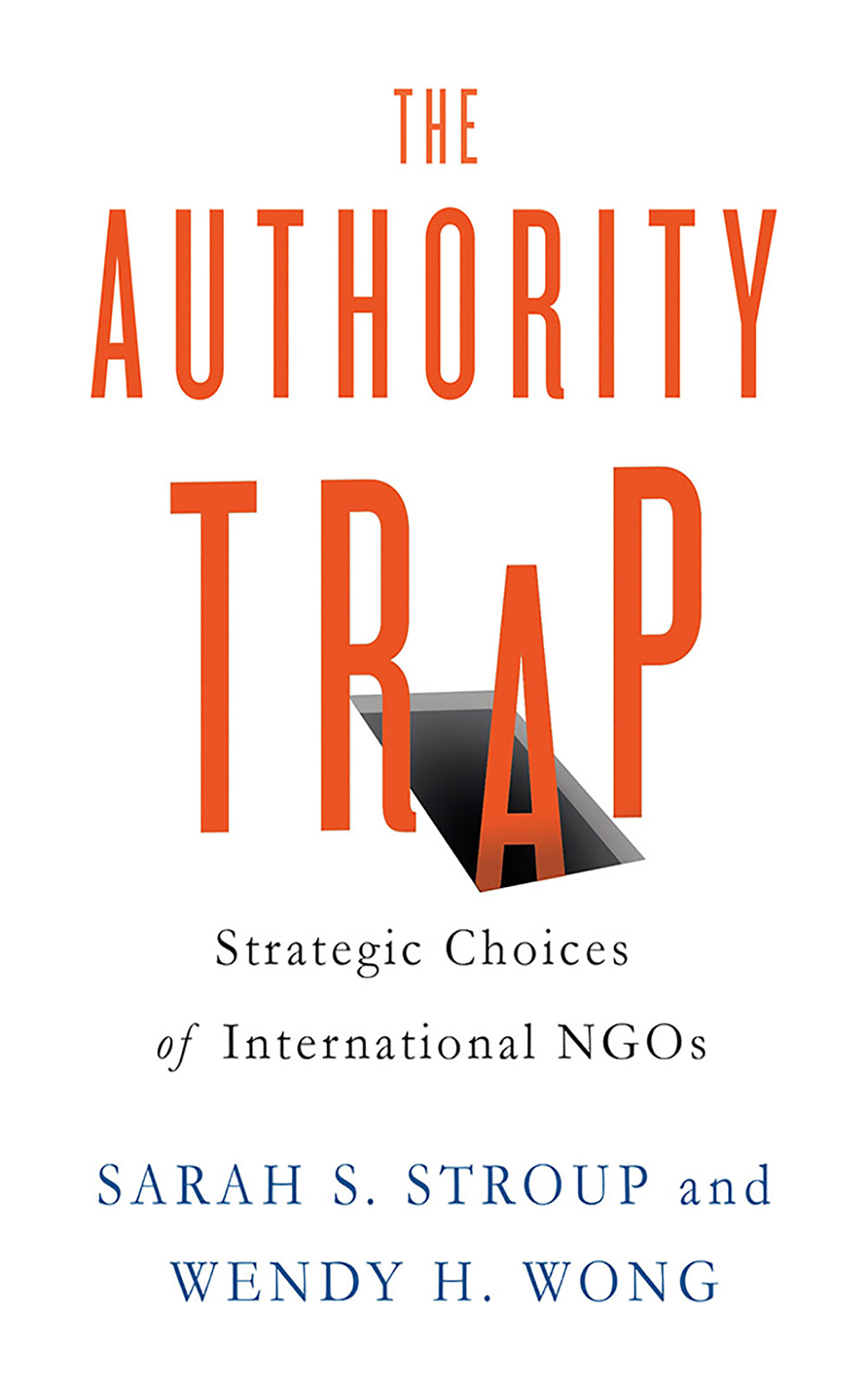
The Authority Trap Not all international nongovernmental organizations (INGOs) are created equal, Some have emerged as "leading INGOs" that command deference from various powerful audiences and are well-positioned to influence the practices of states, corporations, and other INGOs. Yet Sarah S. Stroup and Wendy H. Wong make a strong case for the tenuous nature of this position: in order to retain their authority, INGOs such as Greenpeace, Oxfam, and Amnesty International refrain from expressing radical opinions that severely damage their long-term reputation. Stroup and Wong contend such INGOs must constantly adjust their behavior to maintain a delicate equilibrium that preserves their status. Activists, scholars, and students seeking to understand how international organizations garner and conserve power—and how this affects their ability to fulfill their stated missions—will find much of value in The Authority Trap. The authors use case studies that illuminate how INGOs are received by three main audiences: NGO peers, state policymakers, and corporations. In the end, the authors argue, the more authority an INGO has, the more constrained is its ability to affect the conduct of world politics. POLITICAL SCIENCE,NGOs (Non-Governmental Organizations)
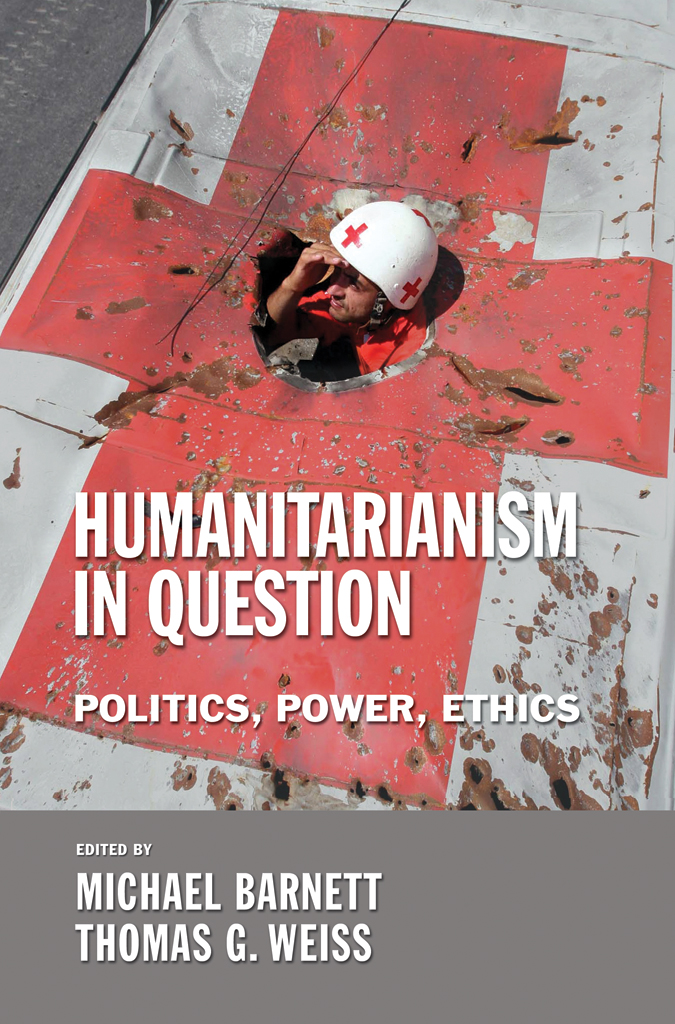
Humanitarianism in Question Years of tremendous growth in response to complex emergencies have left a mark on the humanitarian sector. Various matters that once seemed settled are now subjects of intense debate. What is humanitarianism? Is it limited to the provision of relief... POLITICAL SCIENCE,NGOs (Non-Governmental Organizations)

The NRA For the first time, the definitive account of America’s most powerful, most secretive, and most controversial nonprofit, and how far it has strayed from its origins. The National Rifle Association is unique in American life. Few other civic organizations are as old or as large. None is as controversial. It is largely due to the NRA that the U.S. gun policy differs so extremely — some would say so tragically — from that of every other developed nation. But, as Frank Smyth shows, the NRA has evolved from an organization concerned above all with marksmanship — and which supported most government efforts around gun control for a hundred years — to one that resists all attempts to restrict guns in any way. At the same time, the organization has also buried its own remarkable history. Here is that story, from the NRA’s surprising roots in post-Civil War New York City to the defining event that changed its culture forever — the so called “Cincinnati Revolt†of 1977 — to the present day, where President Donald Trump is the most ardent champion in the White House the NRA has ever had. For anyone who has looked at access to guns in our society and asked “Why?â€, this is an unmatched account of how we got here, and who got us here. POLITICAL SCIENCE,NGOs (Non-Governmental Organizations)

The Pro-Life Pregnancy Help Movement There is more to the pro-life movement than campaigning against abortion. That, at least, is the logic behind a large and growing network of pro-life pregnancy centers offering “help†to pregnant women. As these centers face increasing scrutiny, this book offers the first social-scientific study of the pro-life pregnancy help movement. The work being performed at pro-life pregnancy centers, maternity homes, and other charitable agencies is, Laura S. Hussey suggests, distinguished by several strategic features: it is directed at non-state targets, operates in largely privatized venues, employs service provision as its primary tactic, and aims to address causes popularly associated with its countermovement such as women’s (including poor women’s) wellbeing and empowerment. The motives and nature of the services such pregnancy centers deliver have become the subjects of competing political narratives—but, until now, very little empirical research. A rich, mixed-method study including data from two original national surveys and extensive interviews, Hussey’s book adjudicates these opposing views even as it provides a measured look at the identity, work, history, and impact of pro-life pregnancy centers and related service providers, as well as their relations with the larger American antiabortion movement. To what extent is pro-life pregnancy help work primarily geared to serving women versus “saving babies?†Pursued in these pages, the answer has broad implications for the wider study of social action and the pro-life movement, and for the future of the American abortion conflict. POLITICAL SCIENCE,NGOs (Non-Governmental Organizations)
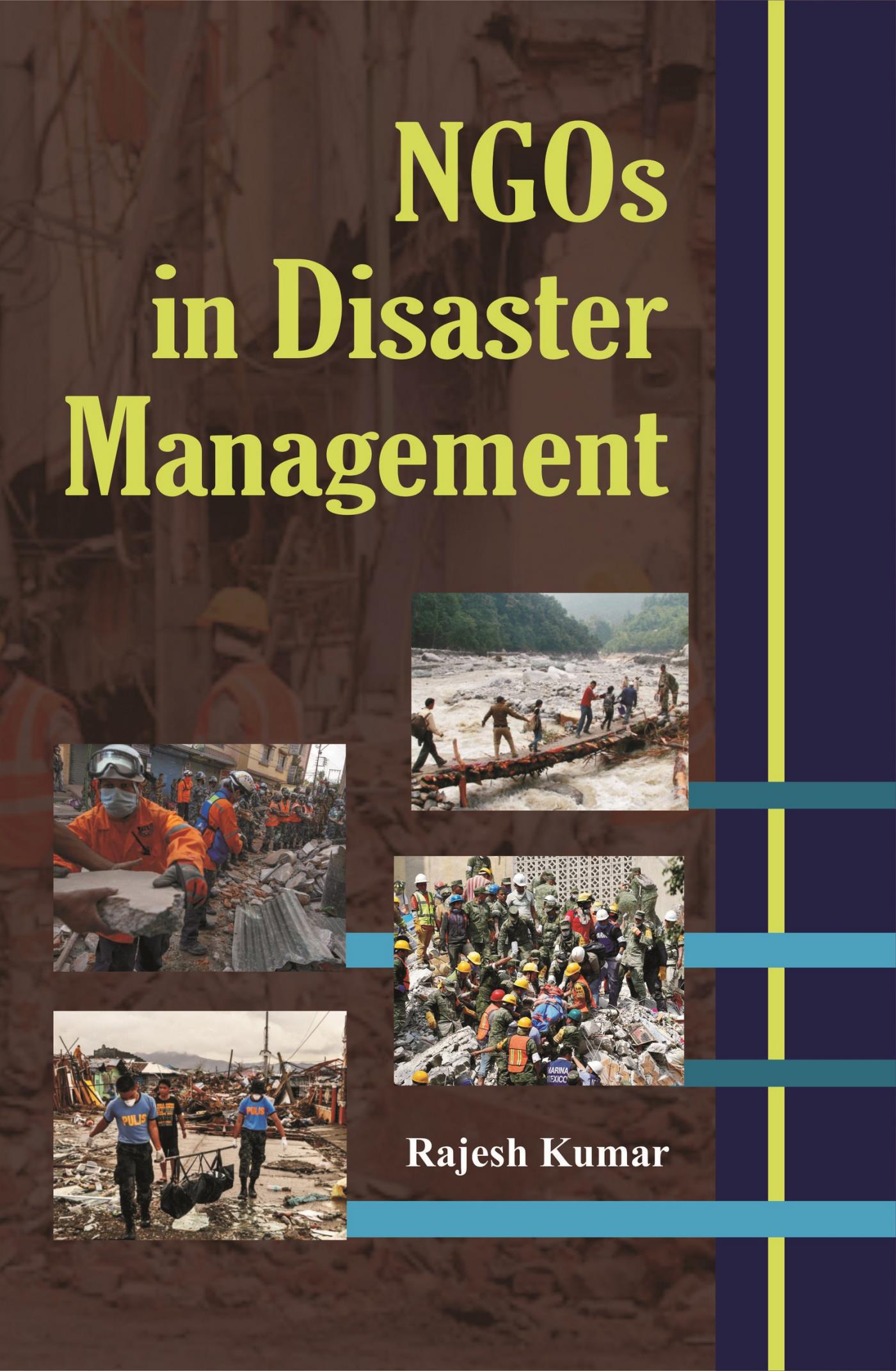
NGOs And Disaster Management Anon-government organization has been defined as any non-profit, voluntary citizen's group, which is organized on a local, national or international level. However the diversity in task, goal and activities, strains any simple definition of NGO. The disaster management framework can be defined as different elements of the disaster cycle, which is composed of actions before disaster, actions immediately after disaster and long-term recovery process after disaster. Although it is more or less similar to different types of disasters, in the current discussion, specific emphasis will be given to the earthquake disasters. In disaster situations, a quick rescue and relief mission is inevitable, however considerable damage can be minimised if adequate preparedness levels are achieved. Indeed, it has been noticed in the past that as and when attention has been given to adequate preparedness measures, the loss to life and property has considerably reduced. Preparedness measures such as training of role players including the community, development of advanced forecasting systems, effective communications and above all a well-networked institutional structure involving the government organisations; academic and research institutions, the armed forces and the NGOs would greatly contribute to the overall disaster management of the region. The government's recent policy changes too reflect the changing approach from rescue and relief to preparedness. The book can be used as a ready reckoner/reference material for enlightening on the topics of concern for and NGO. The checklists, forms, specimens and formats can be used to a great extent. POLITICAL SCIENCE,NGOs (Non-Governmental Organizations)

Europeanization in Sweden Notwithstanding its many successes since 1945, the project of European integration currently faces major difficulties, from financial crises and mass immigration to the impending departure of the UK from the European Union. At the same time, these challenges have spurred civil society organizations within and across Europe, revealing a shared public sphere in which citizens can mobilize around refugee rights, opposition to austerity policies, and other issues. Europeanization in Sweden assembles new empirical research on how these processes have played out in one of the continent’s wealthiest nations, providing insights into whether, and how, the “Swedish model†can guide European integration. POLITICAL SCIENCE,NGOs (Non-Governmental Organizations)
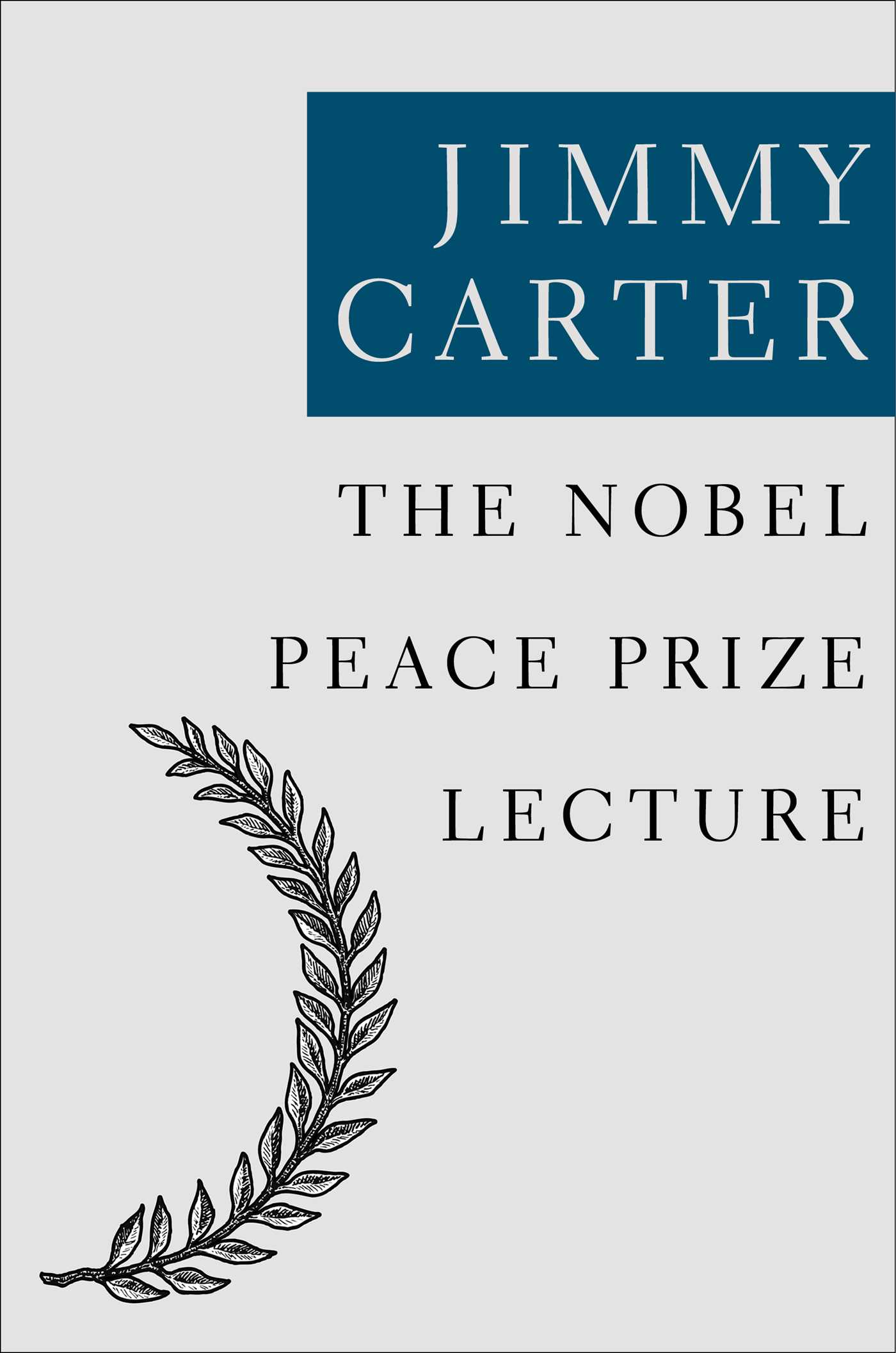
The Nobel Peace Prize Lecture The Nobel Lecture was delivered by Jimmy Carter on December 10, 2002, at the ceremony in Oslo, Norway, where he received the Nobel Prize for Peace. POLITICAL SCIENCE,Peace

Murder in Amsterdam A revelatory look at what happens when political Islam collides with the secular West Ian Buruma's Murder in Amsterdam is a masterpiece of investigative journalism, a book with the intimacy and narrative control of a crime novel and the analytical brilliance for which Buruma is renowned. On a cold November day in Amsterdam in 2004, the celebrated and controversial Dutch filmmaker Theo van Gogh was shot and killed by an Islamic extremist for making a movie that "insulted the prophet Mohammed." The murder sent shock waves across Europe and around the world. Shortly thereafter, Ian Buruma returned to his native land to investigate the event and its larger meaning as part of the great dilemma of our time. POLITICAL SCIENCE,Peace

Warriors and Peacemakers Why do some conflicts escalate into violence while others dissipate harmlessly? Under what circumstances will people kill, and why? While homicide has been viewed largely in the pathological terms of "crime" and "deviance," violence, Mark Cooney contends, is a naturally-occurring form of conflict found throughout history and across cultures under certain social conditions. Cooney has analyzed the social control of homicide within and across over 30 societies and interviewed several dozens of prisoners incarcerated for murder or manslaughter, as well as members of their families. Violence such as homicide can only be understood, he argues, by transcending the traditional focus on the social characteristics of the killer and victims, and by looking at the role played by family members, friends, neighbors, onlookers, police officers, and judges. These third parties can be a source of peace or violence, depending on how they are configured in particular cases. Violence flourishes, Cooney demonstrates, when authority is either very strong or very weak and when third-party ties are strong and boundaries between groups sharply defined. Drawing on recent theory in the lively new sociological speciality of conflict management, Mark Cooney has culled a vast array of evidence from modern and preindustrial societies to provide us with the first general sociological analysis of human violence. POLITICAL SCIENCE,Peace
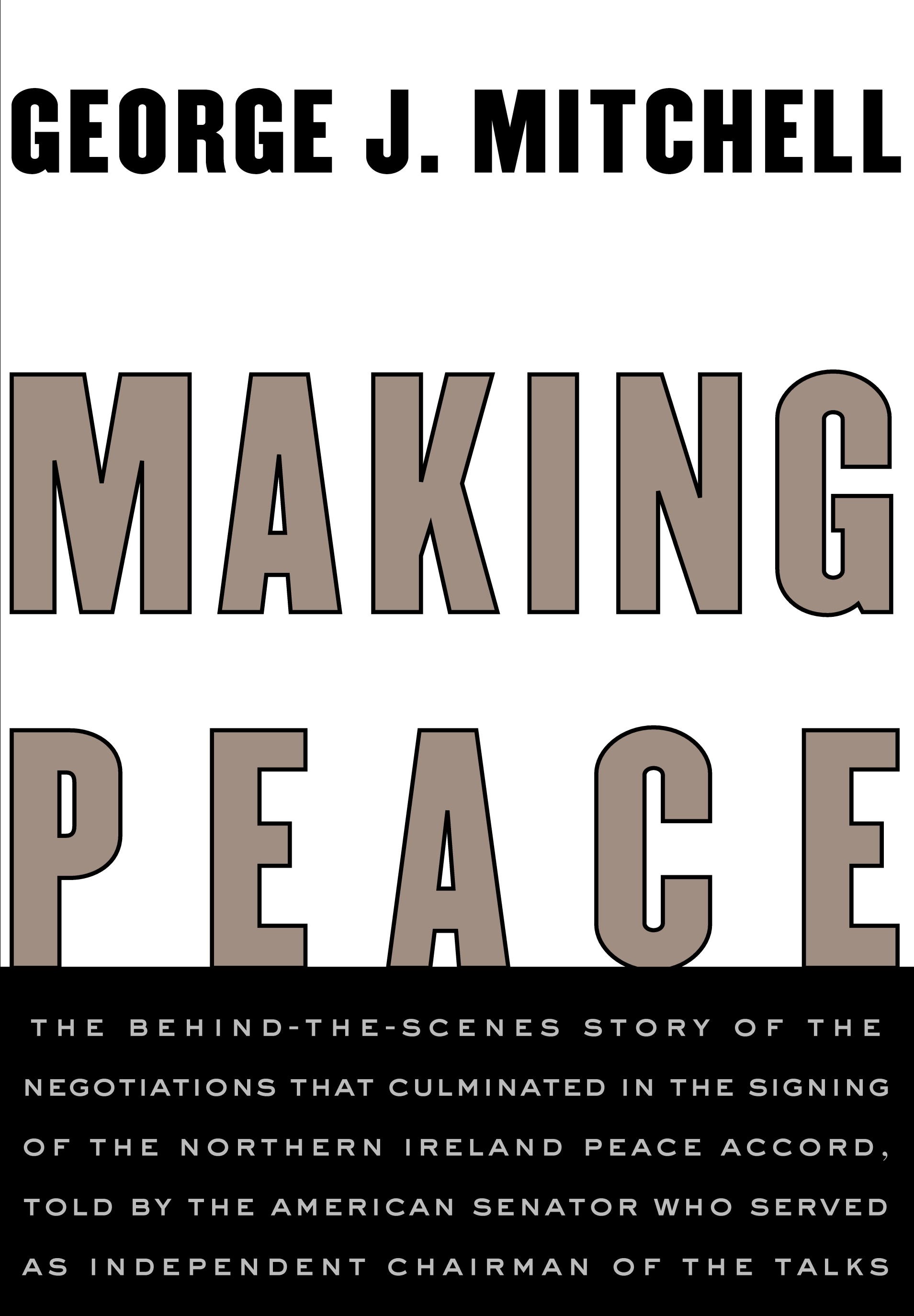
Making Peace Fifteen minutes before five o'clock on Good Friday, 1998, Senator George Mitchell was informed that his long and difficult quest for an Irish peace accord had succeeded--the Protestants and Catholics of Northern Ireland, and the governments of the Republic of Ireland and the United Kingdom, would sign the agreement. Now Mitchell, who served as independent chairman of the peace talks for the length of the process, tells us the inside story of the grueling road to this momentous accord. For more than two years, Mitchell, who was Senate majority leader under Presidents Bush and Clinton, labored to bring together parties whose mutual hostility--after decades of violence and mistrust--seemed insurmountable: Sinn Fein, represented by Gerry Adams; the Catholic moderates, led by John Hume; the majority Protestant party, headed by David Trimble; Ian Paisley's hard-line unionists; and, not least, the governments of the Republic of Ireland and the United Kingdom, headed by Bertie Ahern and Tony Blair. The world watched as the tense and dramatic process unfolded, sometimes teetering on the brink of failure. Here, for the first time, we are given a behind-the-scenes view of the principal players--the personalities who shaped the process--and of the contentious, at times vitriolic, proceedings. We learn how, as the deadline approached, extremist violence and factional intransigence almost drove the talks to collapse. And we witness the intensity of the final negotiating session, the interventions of Ahern and Blair, the late-night phone calls from President Clinton, a last-ditch attempt at disruption by Paisley, and ultimately an agreement that, despite subsequent inflammatory acts aimed at destroying it, has set Northern Ireland's future on track toward a more lasting peace. POLITICAL SCIENCE,Peace
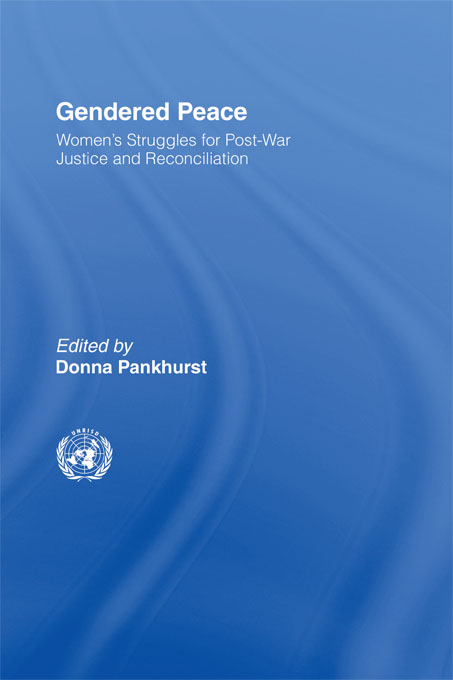
Gendered Peace This volume contributes to the growing literature on women, conflict and peacebuilding by focusing on the moments after a peace accord, or some other official ending of a conflict, often denoted as ‘post-conflict’ or ‘post-war’. Such moments often herald great hope for holding to account those who committed grave wrongs during the conflict, and for a better life in the future. For many women, both of these hopes are often very quickly shattered in starkly different ways to the hopes of men. Such periods are often characterized by violence and insecurities, and the official ending of a war often fails to bring freedom from sexual violence for many women. Within such a context, efforts on the part of women, and those made on their behalf, to hold to account those who commit crimes against them, and to access their rights are difficult to make, are often dangerous, and are also often deployed with little effect. Gendered Peace explores international contexts, and a variety of local ones, in which such struggles take place, and evaluates their progress. The volume highlights the surprising success in the development of international legal advances for women, but contrasts this with the actual experience of women in cases from Sierra Leone, Rwanda, South Africa, Afghanistan, Bangladesh, East Timor, Peru, Central America and the Balkans.' POLITICAL SCIENCE,Peace
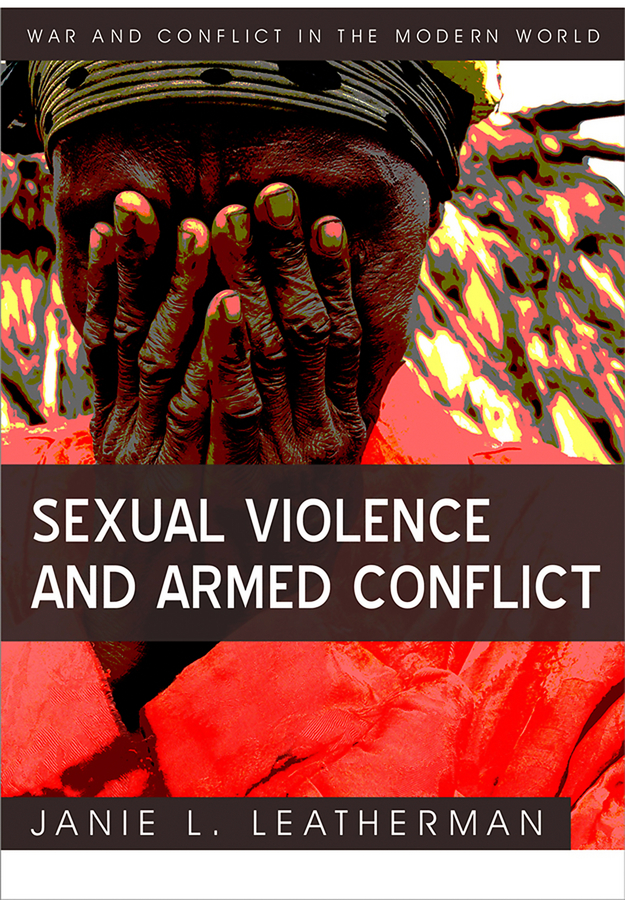
Sexual Violence and Armed Conflict Every year, hundreds of thousands of women become victims of sexual violence in conflict zones around the world; in the Democratic Republic of Congo alone, approximately 1,100 rapes are reported each month. This book offers a comprehensive analysis of the causes, consequences and responses to sexual violence in contemporary armed conflict. It explores the function and effect of wartime sexual violence and examines the conditions that make women and girls most vulnerable to these acts both before, during and after conflict. To understand the motivations of the men (and occasionally women) who perpetrate this violence, the book analyzes the role played by systemic and situational factors such as patriarchy and militarized masculinity. Difficult questions of accountability are tackled; in particular, the case of child soldiers, who often suffer a double victimization when forced to commit sexual atrocities. The book concludes by looking at strategies of prevention and protection as well as new programs being set up on the ground to support the rehabilitation of survivors and their communities. Sexual violence in war has long been a taboo subject but, as this book shows, new and courageous steps are at last being taken à at both local and international level - to end what has been called the “greatest silence in historyâ€. POLITICAL SCIENCE,Peace
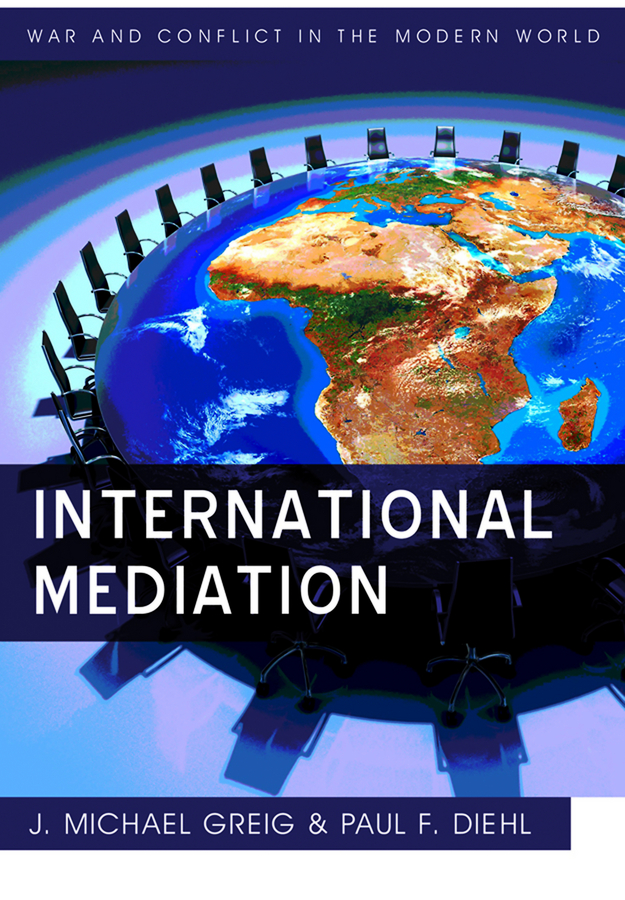
International Mediation Conflicts in the international system, both among and within states, bring death, destruction, and human misery. Understanding how third parties use mediation to encourage settlements and establish a durable peace among belligerents is vital for managing these conflicts. Among many features, this book empirically examines the history of post-World War II mediation efforts to: Chart the historical changes in the types of conflicts that mediation addresses and the links between different mediation efforts across time. Explore the roles played by providers of mediation in the international system - namely, individuals, states, and organizations - in managing violent conflicts. Gauge the influence of self-interest and altruism as motivating forces that determine which conflicts are mediated and which are ignored. Evaluate what we know about the willingness of parties in conflict to accept mediation, when and why it is most effective, and discuss the future challenges facing mediators in the contemporary world. Drawing on a wide range of examples from the Oslo Accords and Good Friday Agreement to efforts to manage the civil wars in Burundi, Tajikistan, and Bosnia, this book is an indispensable guide to international mediation for students, practitioners, and general readers seeking to understand better how third parties can use mediation to deal with the globe’s trouble spots. POLITICAL SCIENCE,Peace

Three Guineas The author received three separate requests for a gift of one guinea-one for a women’s college building fund, one for a society promoting the employment of professional women, and one to help prevent war and “protect culture, and intellectual liberty.†This book is a threefold answer to these requests-and a statement of feminine purpose. POLITICAL SCIENCE,Peace

Peace Operations As peace operations become the primary mechanism of conflict management used by the UN and regional organizations, understanding their problems and potential is essential for a more secure world. In this revised and updated second edition, Paul Diehl and Alexandru Balas provide a cutting-edge analysis of the central issues surrounding the development, operation, and effectiveness of peace operations. Among many features, the book: Traces the historical development of peace operations from their origins in the early 20th century through the development of modern peacebuilding missions and multiple simultaneous peace operations. Tracks changes over time in the size, mission and organization of peace operations. Analyses different organizational, financial, and troop provisions for peace operations, as well as assessing alternatives. Lays out criteria for evaluating peace operations and details the conditions under which such operations are successful. Drawing on a wide range of examples from those between Israel and her neighbours to more recent operations in Bosnia, Somalia, Darfur, East Timor, and the Congo, this new edition brings together the body of scholarly research on peace operations to address those concerns. It will be an indispensable guide for students, practitioners and general readers wanting to broaden their knowledge of the possibilities and limits of peace operations today. POLITICAL SCIENCE,Peace

Understanding Conflict Resolution Providing students with a clear and systematic overview of the field, this fourth edition has plenty of updated coverage including that of Syria, R2P, and the relationship between social media and peace, and is now accompanied by an extensive student study website. POLITICAL SCIENCE,Peace

The Future of Strategy Strategy is not a modern invention. It is an essential and enduring feature of human history that is here to stay. In this original essay, Colin S. Gray, world-renowned scholar of strategic thought, discusses the meaning of strategy and its importance for politicians and the military as a means of achieving desired outcomes in complex, uncertain conditions. Drawing on a wide range of examples from the Great Peloponnesian War to the Second World War, Vietnam, and the ongoing conflicts in Iraq and Afghanistan, Gray ably shows how great military thinkers of the past and present have acted strategically in their various ideological, political, geographical and cultural contexts. Looking to the future, he argues that strategy will continue to provide a vital tool-kit for survival and security, but that the global threat posed by nuclear weapons remains an on-going challenge without obvious practical solutions. As Gray boldy asserts, there is no promised land ahead, only hard and dangerous times that will require us to master the theory and practice of strategy to secure our own future. POLITICAL SCIENCE,Peace

Transformative Change This book is designed as an undergraduate textbook to be used as a foundation text for peace and conflict studies (PACS) programs or for anyone interested in an overview of the field of peace and conflict studies. The book provides an introduction to the field balancing theory, research, and practice. POLITICAL SCIENCE,Peace
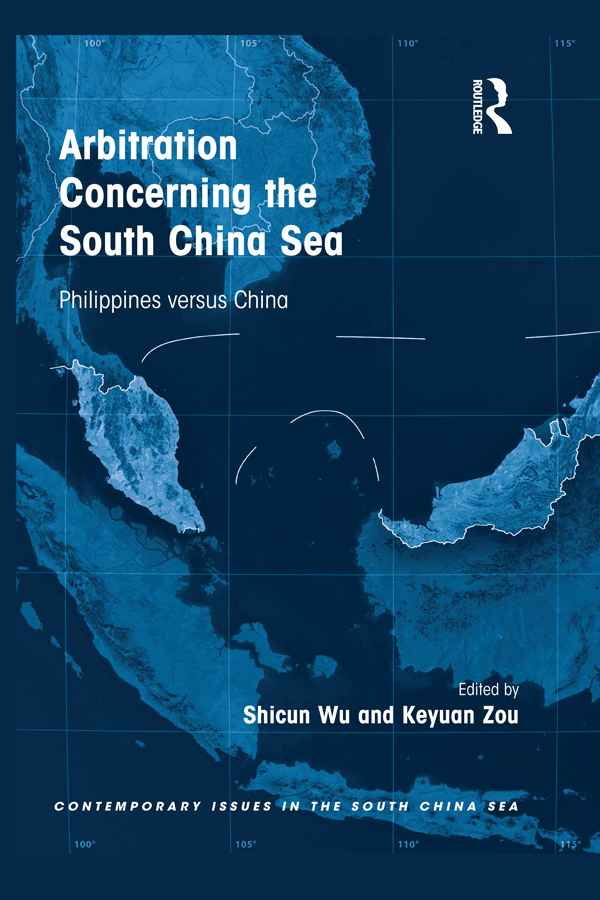
Arbitration Concerning the South China Sea On 22 January 2013, the Republic of the Philippines instituted arbitral proceedings against the People’s Republic of China (PRC) under the United Nations Convention on the Law of the Sea (UNCLOS) with regard to disputes between the two countries in the South China Sea. The South China Sea Arbitration is a landmark case in international law because of the parties involved, the legal questions to be decided and the absence of one of the parties. As revealed in its official statements, the PRC will neither accept nor participate in this arbitration nor present written and oral arguments in the tribunal room. Such default of appearance makes applicable certain procedural rules. According to Article 9 of Annex VII, the Tribunal, before making its Award, is obligated to satisfy itself not only that it has jurisdiction over the dispute, but also that the claims brought by the Philippines are well-founded in fact and law. Therefore, it is necessary for the Tribunal to look into all the claims brought forward by the Philippines and all the disputes constituted by the claims in the procedural phase. The possible arguments the PRC could make should be explored during this process. This book brings together chapters selected from well-established scholars in Asia, Europe and North America addressing the issues arising from the South China Sea Arbitration. It contains five easy to read parts: origin and development of the South China Sea dispute; the jurisdiction and admissibility of the case; international adjudication and dispute settlement; legal issues arising from the case such as the legal status of the U-shaped line and islands, rocks and low-tide elevations; and the Arbitration case and its impact on regional maritime security. POLITICAL SCIENCE,Peace
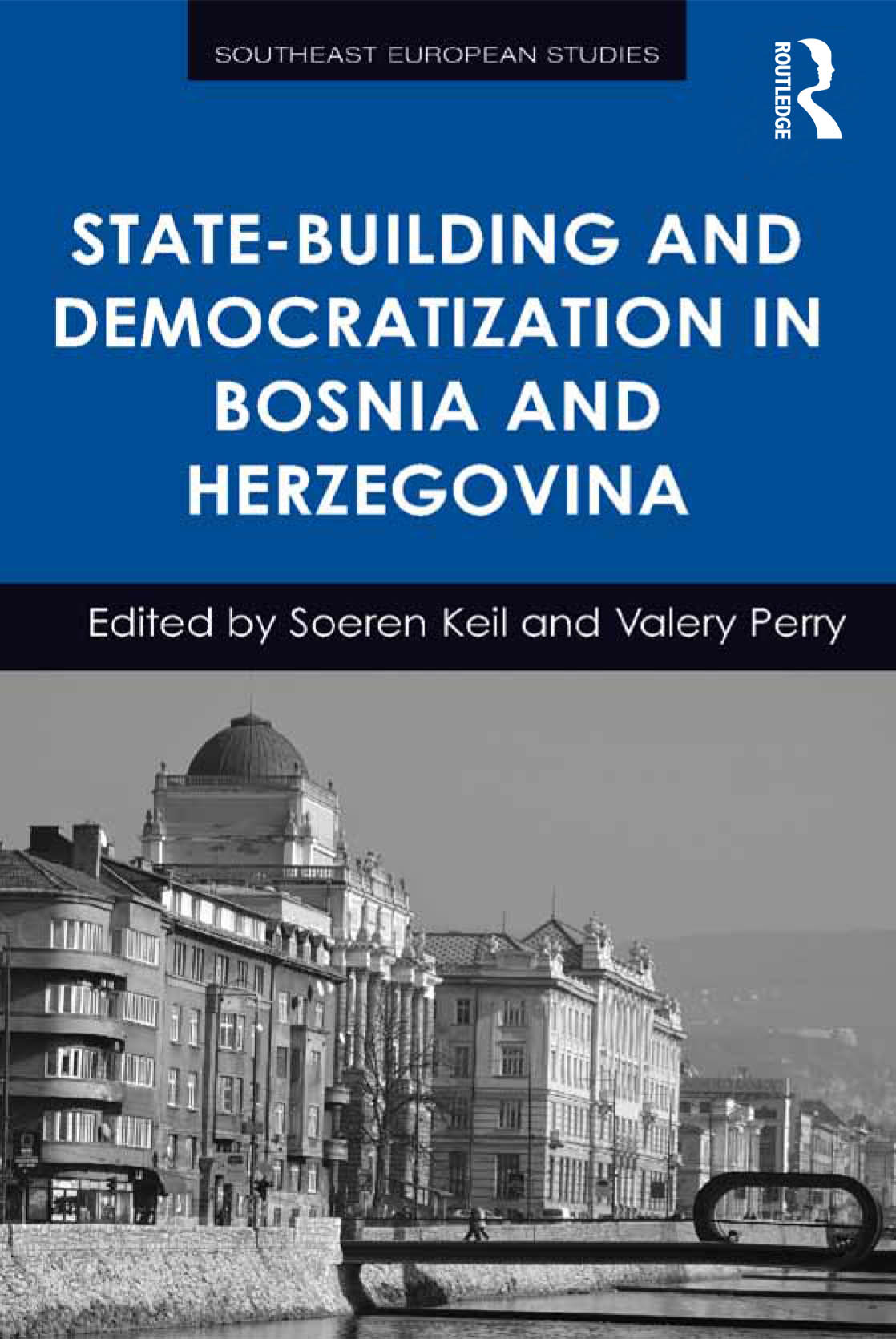
State-Building and Democratization in Bosnia and Herzegovina State Building and Democratization in Bosnia and Herzegovina details the post-Dayton evolution of the country over the last two decades. Carefully evaluating the successes and failures the book explores the slow progress of the democratization process and how key elites initially took hold of the state and its institutions and have successfully retained their grip on power, despite heavy international presence and reform attempts to counter-balance this trend. Bosnia and Herzegovina offers a useful lens through which to view international state-building and democratization efforts. International engagement here incorporated significant civilian and military investment and has been ongoing for many years. In each chapter international scholars and field-based practitioners examine the link between post-war events and a structure that effectively embeds ethno-national politics and tensions into the fabric of the country. These contributors offer lessons to be learned, and practices to be avoided whilst considering whether, as state-building and democratization efforts have struggled in this relatively advanced European country, they can succeed in other fragile states. POLITICAL SCIENCE,Peace
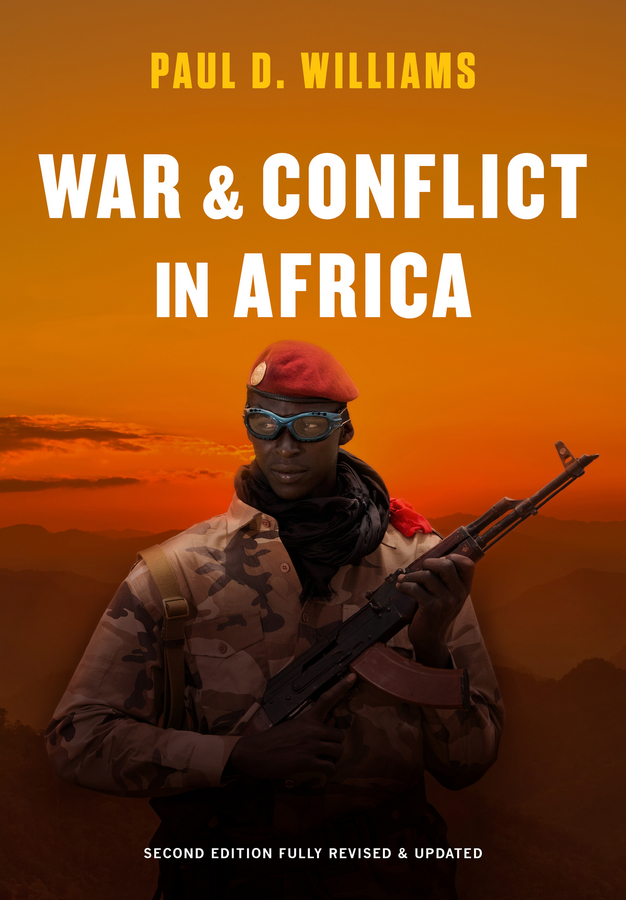
War and Conflict in Africa After the Cold War, Africa earned the dubious distinction of being the world's most bloody continent. But how can we explain this proliferation of armed conflicts? What caused them and what were their main characteristics? And what did the world's governments do to stop them? In this fully revised and updated second edition of his popular text, Paul Williams offers an in-depth and wide-ranging assessment of more than six hundred armed conflicts which took place in Africa from 1990 to the present day - from the continental catastrophe in the Great Lakes region to the sprawling conflicts across the Sahel and the web of wars in the Horn of Africa. Taking a broad comparative approach to examine the political contexts in which these wars occurred, he explores the major patterns of organized violence, the key ingredients that provoked them and the major international responses undertaken to deliver lasting peace. Part I, Contexts provides an overview of the most important attempts to measure the number, scale and location of Africa's armed conflicts and provides a conceptual and political sketch of the terrain of struggle upon which these wars were waged. Part II, Ingredients analyses the role of five widely debated features of Africa's wars: the dynamics of neopatrimonial systems of governance; the construction and manipulation of ethnic identities; questions of sovereignty and self-determination; as well as the impact of natural resources and religion. Part III, Responses, discusses four major international reactions to Africa's wars: attempts to build a new institutional architecture to help promote peace and security on the continent; this architecture's two main policy instruments, peacemaking initiatives and peace operations; and efforts to develop the continent. War and Conflict in Africa will be essential reading for all students of international peace and security studies as well as Africa's international relations. POLITICAL SCIENCE,Peace

Theories of Violent Conflict This revised and updated second edition introduces students of violent conflict to a variety of prominent theoretical approaches, and examines the ontological stances and epistemological traditions underlying these approaches. Theories of Violent Conflict takes the centrality of the ‘group’ as an actor in contemporary conflict as a point of departure, leaving us with three main questions: • What makes a group? • Why and how does a group resort to violence? • Why and how do or don’t they stop? The book examines and compares the ways by which these questions are addressed from a number of perspectives: primordialism/constructivism, social identity theory, critical political economy, human needs theory, relative deprivation theory, collective action theory and rational choice theory. The final chapter aims to synthesize structure and agency-based theories by proposing a critical discourse analysis of violent conflict. With new material on violence, religion, extremism and military urbanism, this book will be essential reading for students of war and conflict studies, peace studies, conflict analysis and conflict resolution, and ethnic conflict, as well as security studies and IR in general. POLITICAL SCIENCE,Peace

Conflict, War, and Peace Introducing students to the scientific study of peace and war, Conflict, War, and Peace: An Introduction to Scientific Research , edited by Sara McLaughlin Mitchell and John A. Vasquez, provides an overview of current scholarship in this dynamic area of study. Focusing on the factors that shape relationships between countries and that make war or peace more likely, this collection of articles by top scholars explores such key topics as dangerous dyads, alliances, territorial disputes, rivalry, arms races, democracy peace, trade, international organizations, territorial peace, and nuclear weapons. Each article is followed by the editors’ commentary: a “Major Contributions†section highlights the article’s theoretical advances and relates each study to the broader literature, while a “Methodological Notes†section carefully walks students through the techniques used in the analysis. Methodological topics include research design, percentages, probabilities, odds ratios, statistical significance, levels of analysis, selection bias, logic, duration models, and game theory models. POLITICAL SCIENCE,Peace

Civil Society, Peace, and Power The case studies in this volume show the growth of civil society involvement in national, regional, and international peacebuilding policy. The focus is on multi-stakeholder, systems-based approaches to peacebuilding and security that involve diverse civil society groups, government agencies, intergovernmental organizations, and security forces. POLITICAL SCIENCE,Peace
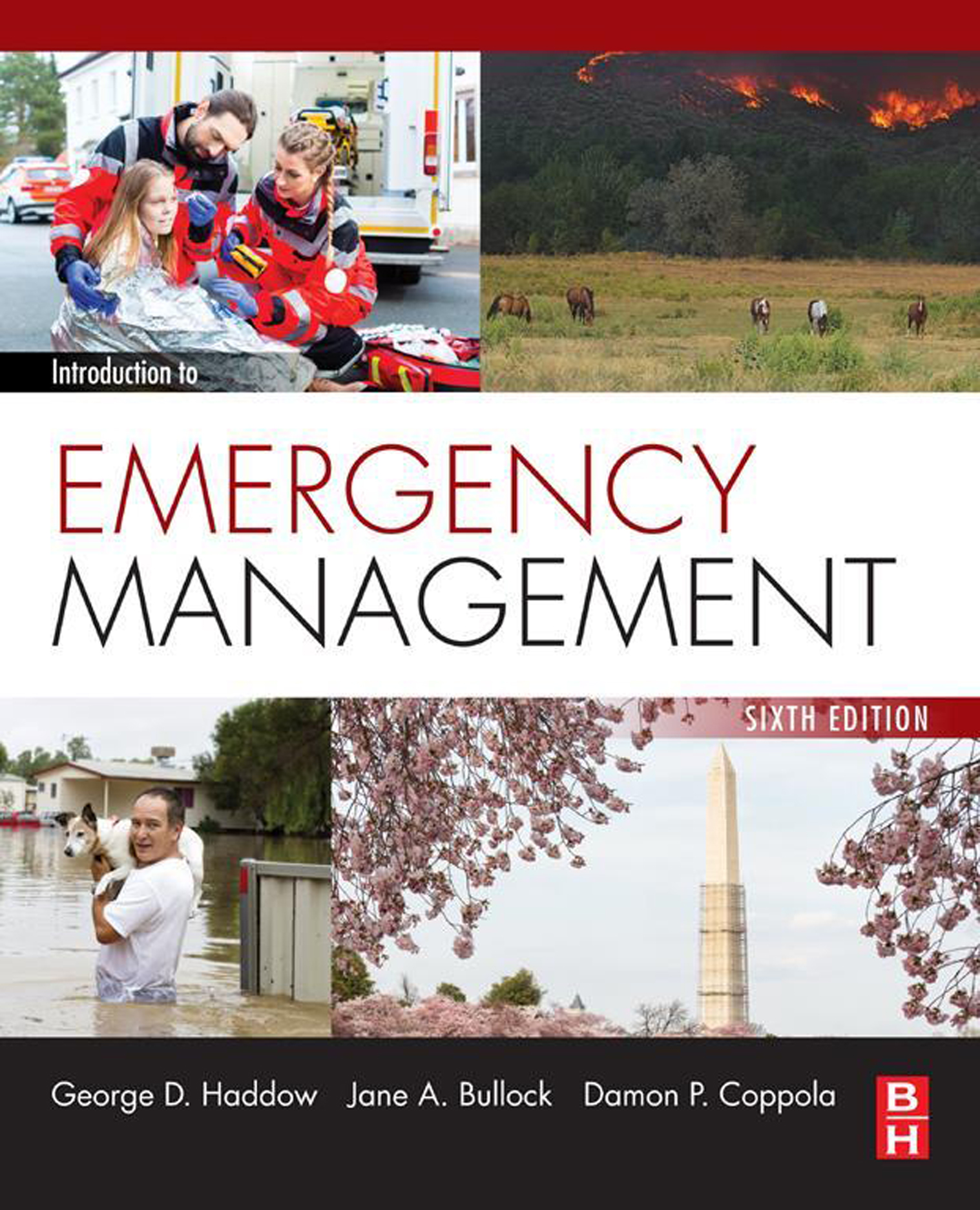
Introduction to Emergency Management Introduction to Emergency Management sets the standard for excellence in the field and has educated a generation of emergency managers. Haddow, Bullock, and Coppola return for the sixth edition with an emphasis on climate change as a major hazard. Fully updated throughout for new regulations and workflows, with new case studies covering the latest in best practices, this classic textbook prepares students for the challenges of a career in emergency management. Expanded information on disaster recovery coordination structures Emphasis on climate change as a key hazard faced by disaster managers Coverage of social media as critical tool in emergency management Fully updated throughout for the latest regulations and workflows New examples and case studies throughout Updated ancillaries to keep course instruction fresh POLITICAL SCIENCE,Peace
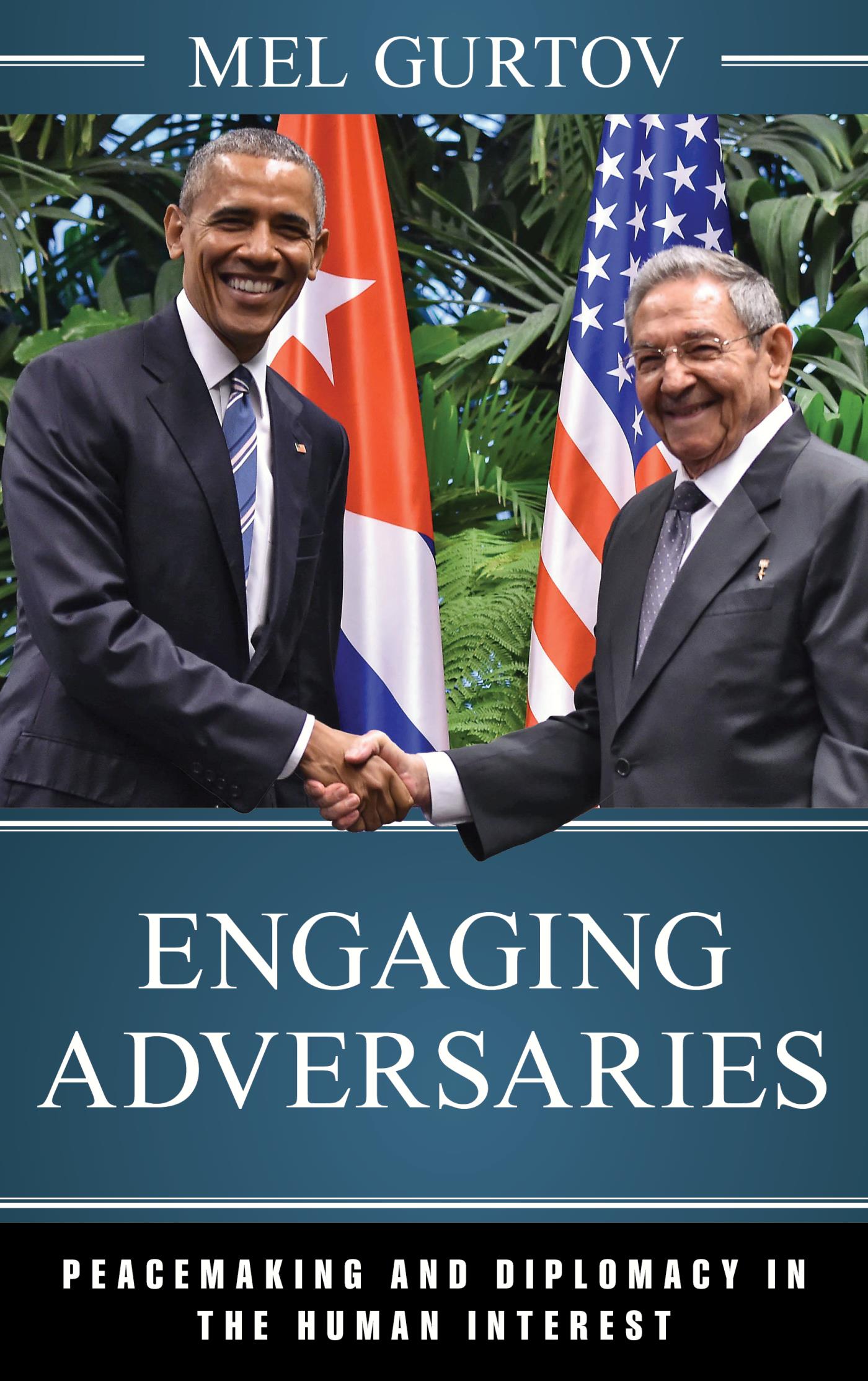
Engaging Adversaries This groundbreaking book explores how adversaries in world politics can surmount their differences and disputes and start on the path to peaceful, productive relations. Gurtov draws lessons for diplomatic ways to engage, such as practicing mutual respect, paying attention to symbols, and using incentives rather than sanctions to find common ground. POLITICAL SCIENCE,Peace

Truth, Justice and Reconciliation in Colombia The signing of the peace agreements between the FARC-EP and the Colombian Government in late November 2016 has generated new prospects for peace in Colombia, opening the possibility of redressing the harm inflicted on Colombians by Colombians. Talking about peace and transitional justice requires us to think about how to operationalize peace agreements to promote justice and coexistence for peace. This volume brings together reflections by Colombian academics and practitioners alongside pieces provided by researchers and practitioners in other countries where transitional justice initiatives have taken place (Bosnia and Herzegovina, South Africa, Sri Lanka and Peru). This volume has been written in the south, by the south, for the south. The book engages with the challenges ahead for the coming generations of Colombians. Rivers of ink have dealt with the end goals of transitional justice, but victims require us to take the quest for human rights beyond the normative realm of theorizing justice and into the practical realm of engaging how to implement justice initiatives. The tension between theory—the legislative frameworks guaranteeing human rights—and practice—the realization of these ideas—will frame Colombia’s success (or failure) in consolidating the implementation of the peace agreements with the FARC-EP. POLITICAL SCIENCE,Peace
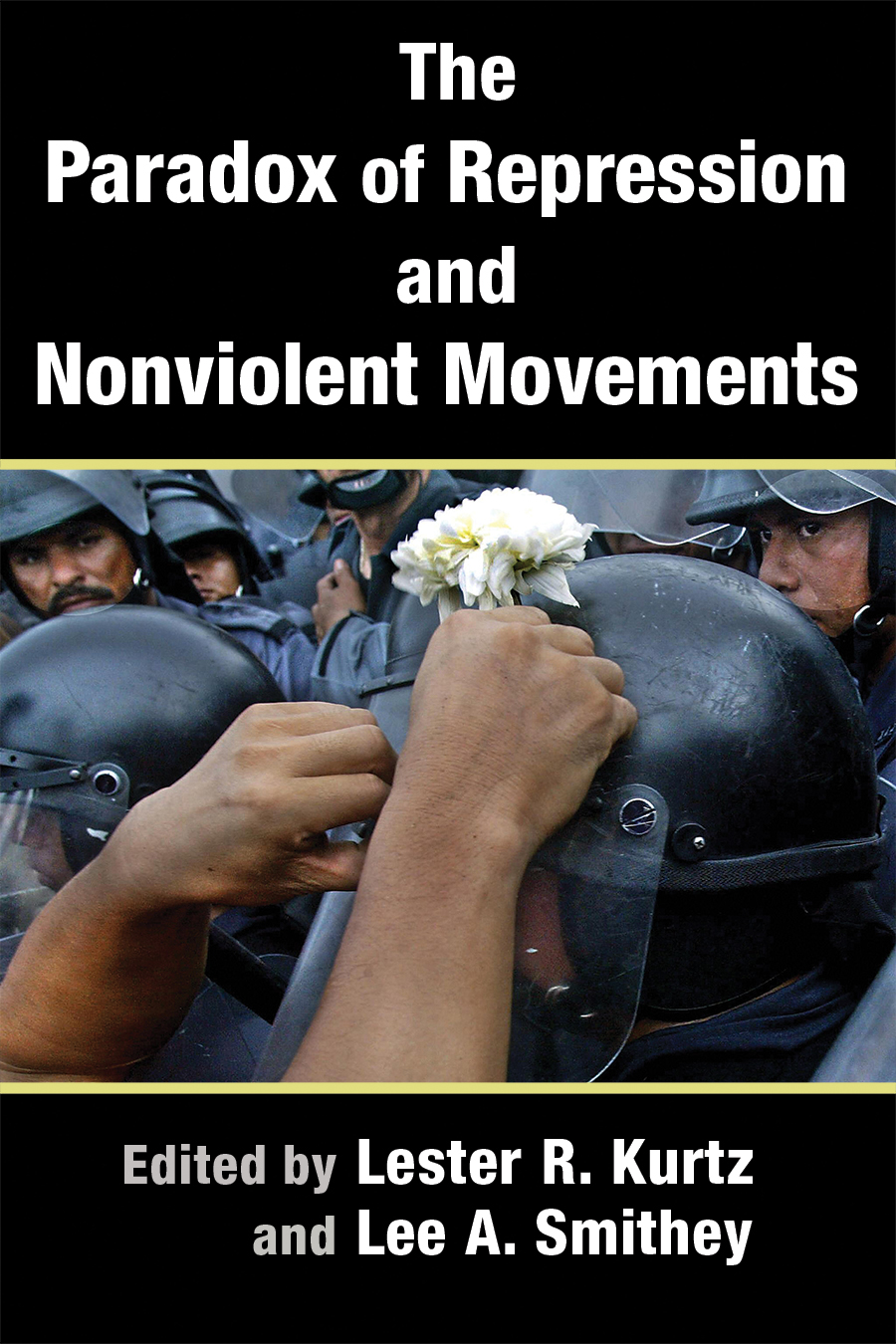
The Paradox of Repression and Nonviolent Movements Political repression often paradoxically fuels popular movements rather than undermining resistance. When authorities respond to strategic nonviolent action with intimidation, coercion, and violence, they often undercut their own legitimacy, precipitating significant reforms or even governmental overthrow. Brutal repression of a movement is often a turning point in its history: Bloody Sunday in the March to Selma led to the passage ofcivil rights legislation by the US Congress, and the Amritsar Massacre in India showed the world the injustice of the British Empire’s use of force in maintaining control over its colonies. Activists in a wide range of movements have engaged in nonviolent strategies of repression management that can raise the likelihood that repression will cost those who use it. The Paradox of Repression and Nonviolent Movements brings scholars and activists together to address multiple dimensions and significant cases of this phenomenon, including the relational nature of nonviolent struggle and the cultural terrain on which it takes place, the psychological costs for agents of repression, and the importance of participation, creativity, and overcoming fear, whether in the streets or online. POLITICAL SCIENCE,Peace
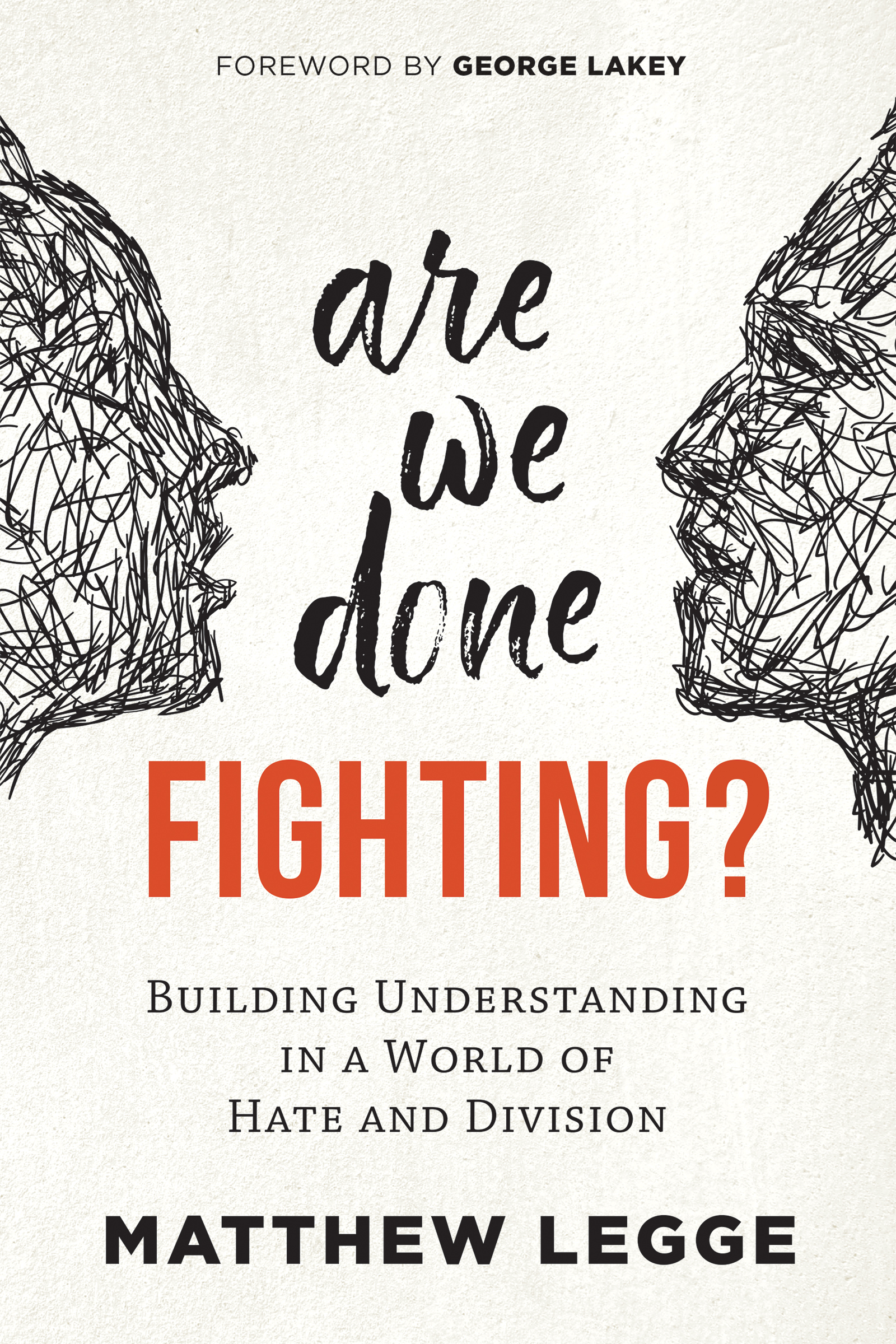
Are We Done Fighting? Are We Done Fighting? provides research, practical activities, and inspirational stories of success for cultivating inner change and spreading peace at the community level and beyond. Essential for everyone working to build understanding as an antidote to the politics of hate and division. POLITICAL SCIENCE,Peace
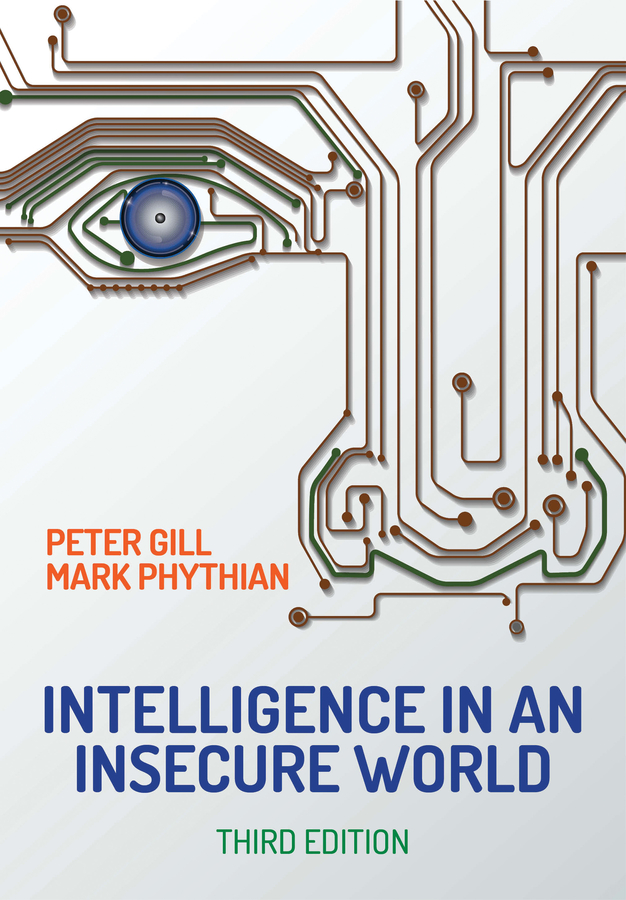
Intelligence in An Insecure World Security intelligence continues to be of central importance to the contemporary world: individuals, organizations and states all seek timely and actionable intelligence in order to increase their sense of security. But what exactly is intelligence? Who seeks to develop it and to what ends? How can we ensure that intelligence is not abused? In this third edition of their classic text, Peter Gill and Mark Phythian set out a comprehensive framework for the study of intelligence, discussing how states organize the collection and analysis of information in order to produce intelligence, how it is acted upon, why it may fail and how the process should be governed in order to uphold democratic rights. Fully revised and updated throughout, the book covers recent developments, including the impact of the Snowden leaks on the role of intelligence agencies in Internet and social media surveillance and in defensive and offensive cyber operations, and the legal and political arrangements for democratic control. The role of intelligence as part of ‘hybrid’ warfare in the case of Russia and Ukraine is also explored, and the problems facing intelligence in the realm of counterterrorism is considered in the context of the recent wave of attacks in Western Europe. Intelligence in an Insecure World is an authoritative and accessible guide to a rapidly expanding area of inquiry – one that everyone has an interest in understanding. POLITICAL SCIENCE,Peace

Choosing Peace Drawing on the voices and experiences of community-based peace leaders around the world, this book envisions a new way of working together as a truly local and global peacebuilding field. POLITICAL SCIENCE,Peace

The Rise and Fall of Peacebuilding in the Balkans This book examines the evolution of liberal peacebuilding in the Balkans since the mid-1990s. After more than two decades of peacebuilding intervention, widespread popular disappointment by local communities is increasingly visible. Since the early 2010s, difficult conditions have spurred a wave of protest throughout the region. Citizens have variously denounced the political system, political elites, corruption and mismanagement. Rather than re-evaluating their strategy in light of mounting local discontent, international peacebuilding officials have increasingly adopted cynical calculations about stability. This book explains this evolution from the optimism of the mid-1990s to the current state through the analysis of three main phases, moving from the initial ‘rise’, to a later condition of ‘stalemate’ and then ‘fall’ of peacebuilding. POLITICAL SCIENCE,Peace
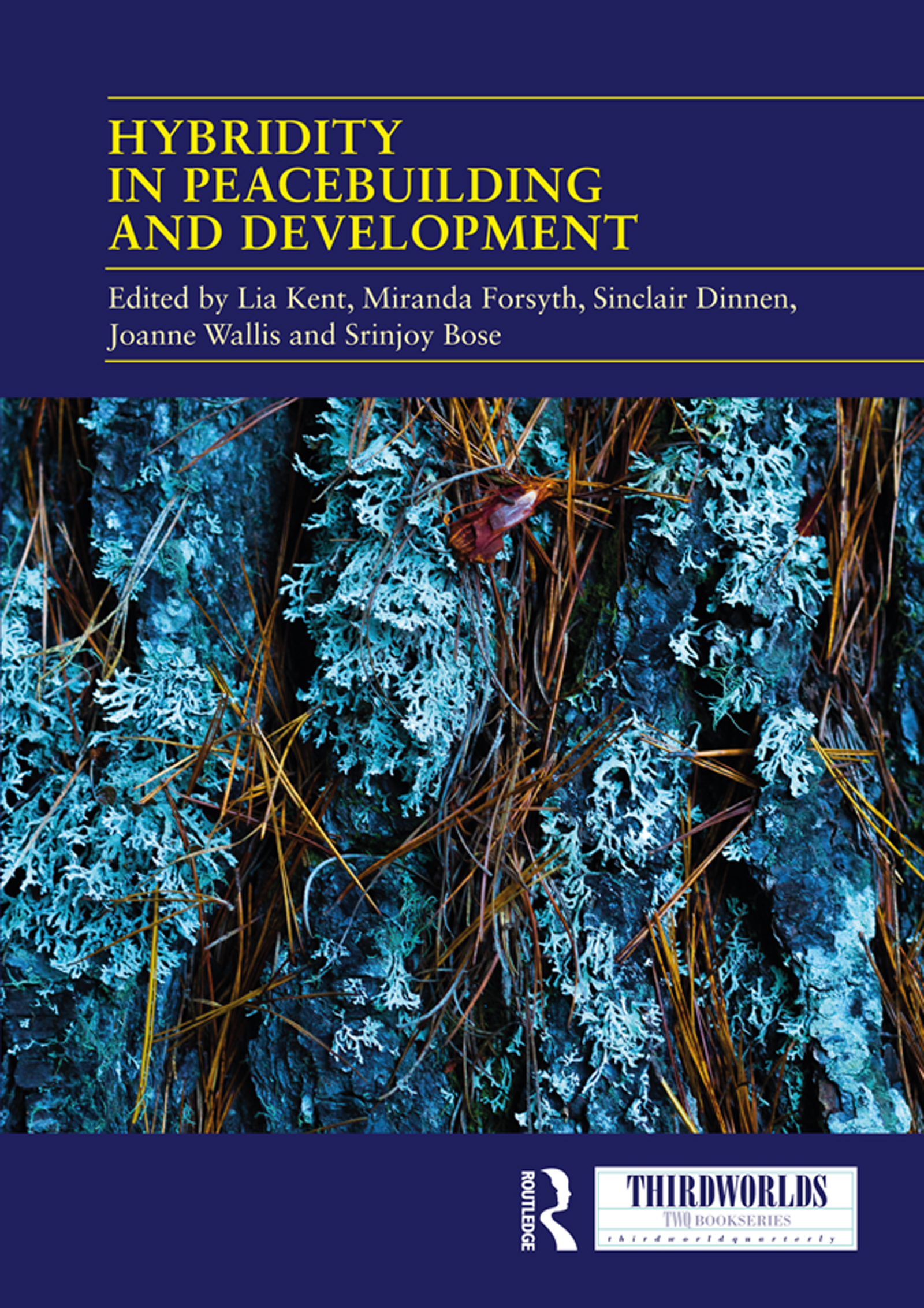
Hybridity in Peacebuilding and Development The concept of hybridity highlights complex processes of interaction and transformation between different institutional and social forms, and normative systems. It has been used in numerous ways to generate important analytical and methodological insights into peacebuilding and development. Its most recent application in the social sciences has also attracted powerful critiques that have highlighted its limitations and challenged its continuing usage. This book examines whether the value of hybridity as a concept can continue to be harnessed, and how its shortcomings might be mitigated or overcome. It does so in an interdisciplinary way, as hybridity has been used as a benchmark across multiple disciplines and areas of practical engagement over the past decade – including peacebuilding, state-building, justice reform, security, development studies, anthropology, and economics. This book encourages a dialogue about the uses and critiques of hybridity from a variety of perspectives and vantage points, including deeply ethnographic works, high-level theory, and applied policy work. The authors conclude that there is continued value in the concept of hybridity, but argue that this value can only be realised if the concept is engaged with in a reflexive and critical way. This book was originally published as a special issue of the online journal Third World Thematics. POLITICAL SCIENCE,Peace
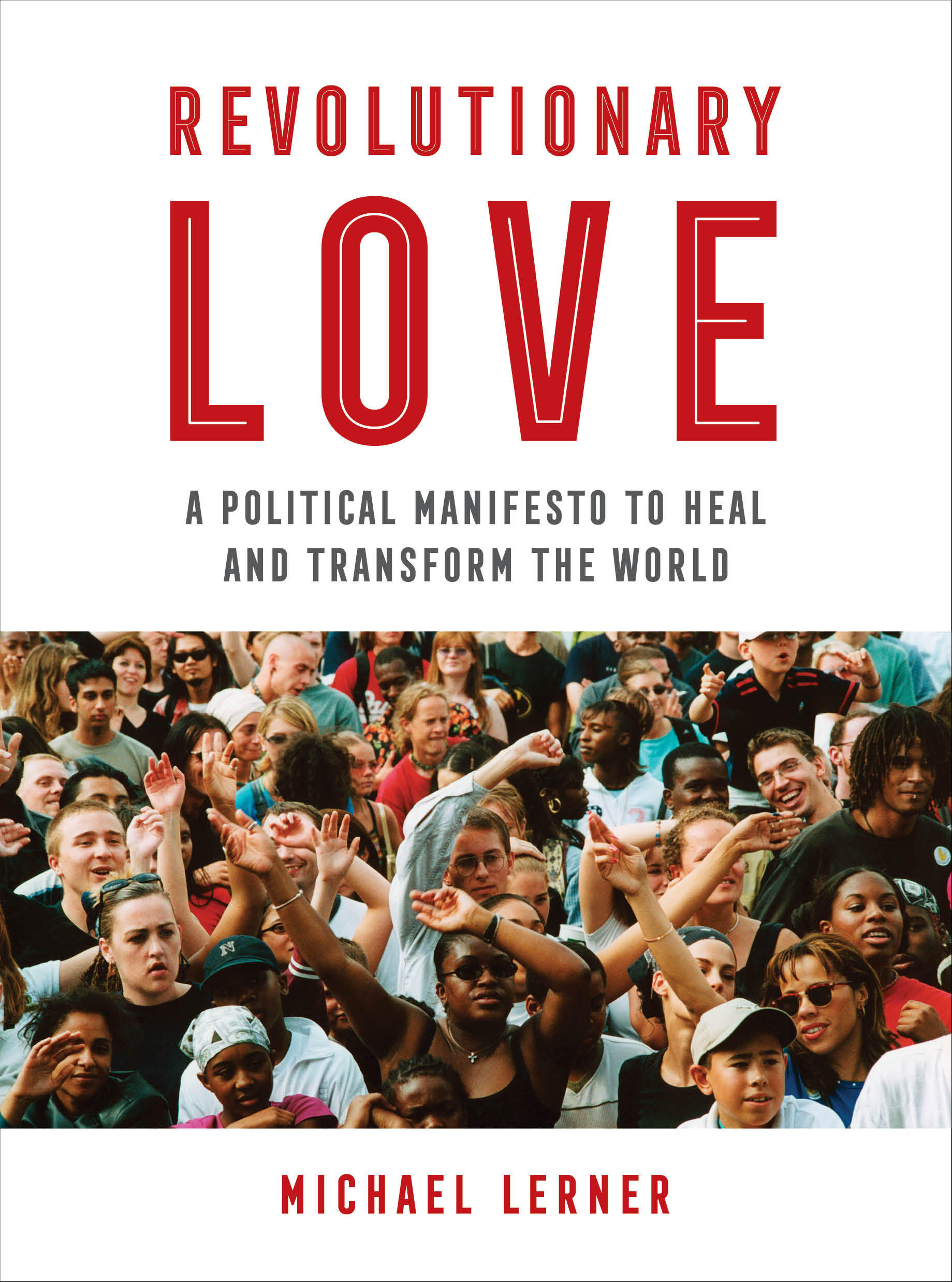
Revolutionary Love From social theorist and psychotherapist Rabbi Michael Lerner comes a strategy for a new socialism built on love, kindness, and compassion for one another. Revolutionary Love proposes a method to replace what Lerner terms the “capitalist globalization of selfishness†with a globalization of generosity, prophetic empathy, and environmental sanity. Lerner challenges liberal and progressive forces to move beyond often weak-kneed and visionless politics to build instead a movement that can reverse the environmental destructiveness and social injustice caused by the relentless pursuit of economic growth and profits. Revisiting the hidden injuries of class, Lerner shows that much of the suffering in our society—including most of its addictions and the growing embrace of right-wing nationalism and reactionary versions of fundamentalism—is driven by frustrated needs for community, love, respect, and connection to a higher purpose in life. Yet these needs are too often missing from liberal discourse. No matter that progressive programs are smartly constructed—they cannot be achieved unless they speak to the heart and address the pain so many people experience. Liberals and progressives need coherent alternatives to capitalism, but previous visions of socialism do not address the yearning for anything beyond material benefits. Inspired by Herbert Marcuse, Erich Fromm, and Carol Gilligan, Revolutionary Love offers a strategy to create the “Caring Society.†Lerner details how a civilization infused with love could put an end to global poverty, homelessness, and hunger, while democratizing the economy, shifting to a twenty-eight-hour work week, and saving the life-support system of Earth. He asks that we develop the courage to stop listening to those who tell us that fundamental social transformation is “unrealistic.†POLITICAL SCIENCE,Peace

Martin McGuinness Personal accounts by people of all political colours from these islands and the wider world who met and interacted with Martin McGuinness at different points in his life: some over a lifetime, others more briefly. POLITICAL SCIENCE,Peace
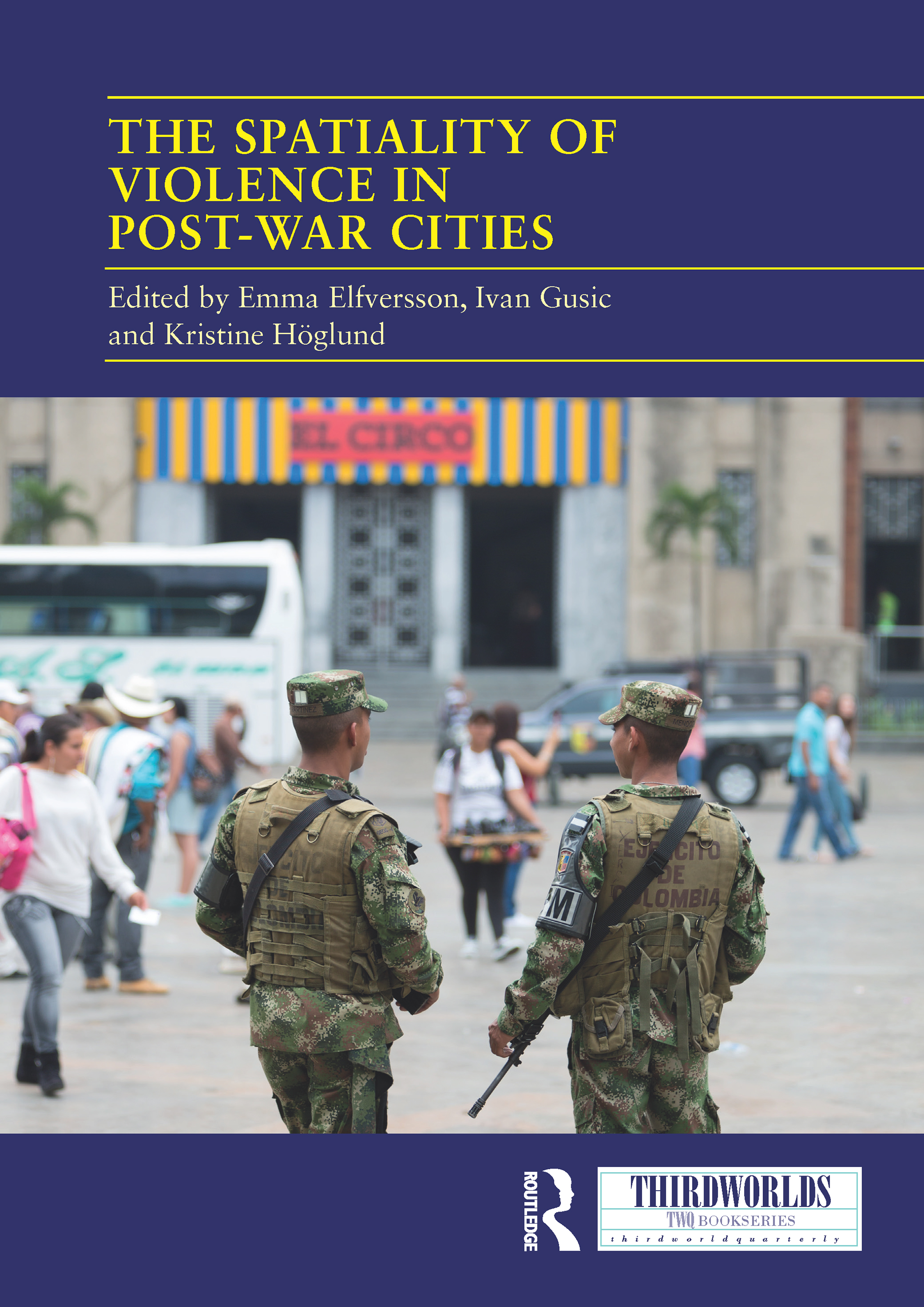
The Spatiality of Violence in Post-war Cities The Spatiality of Violence in Post-war Cities analyses violence in post-war cities from different perspectives and in different parts of the world, with a shared attention to space and how it affects violent dynamics. The world is urbanising rapidly and cities are increasingly held as the most important arenas for sustainable development. Cities emerging from war are no exception, but across the globe, many post-war cities are ravaged by residual or renewed violence, which threatens progress towards peace and stability. This volume addresses why such violence happens, where and how it manifests, and how it can be prevented. It includes contributions that are informed by both post-war logics and urban particularities, that take intra-city dynamics into account, and that adopt a spatial analysis of the city. They focus on cases around the world, including MedellÃn (Colombia), Johannesburg (South Africa) and Mitrovica (Kosovo). The volume makes a threefold contribution to the research agenda on violence in post-war cities. First, the contributions nuance our understanding of the causes and forms of the uneven spatial distribution of violence, insecurities, and trauma within and across post-war cities. Second, the collection demonstrates how urban planning and the built environment shape and generate different forms of violence in post-war cities. Third, the contributions explore the challenges, opportunities, and potential unintended consequences of conflict resolution in violent urban settings. Providing novel insights into the causes and dynamics of violence in post-war cities, and challenges and opportunities for violence reduction, The Spatiality of Violence in Post-war Cities will be of great interest to scholars of peace, violence, conflict and its resolution, urban studies, built environment and planning. The chapters were originally published as a special issue of Third World Thematics. POLITICAL SCIENCE,Peace

Healing and Peacebuilding after War This book brings together multiple perspectives to examine the strengths and limitations of efforts to promote healing and peacebuilding after war, focusing on the aftermath of the traumatic armed conflict in Bosnia and Herzegovina. This book begins with a simple premise: trauma that is not transformed is transferred. Drawing on multidisciplinary insights from academics, peace practitioners and trauma experts, this book examines the limitations of our current strategies for promoting healing and peacebuilding after war while offering inroads into best practices to prevent future violence through psychosocial trauma recovery and the healing of memories. The contributions create a conversation that allows readers to critically rethink the deeper roots and mechanisms of trauma created by the war. Collectively, the authors provide strategic recommendations to policymakers, peace practitioners, donors and international organizations engaged in work in Bosnia and Herzegovina – strategies that can be applied to other countries rebuilding after war. This volume will be of much interest to students of conflict resolution, peacebuilding, social psychology, Balkan politics and International Relations in general. POLITICAL SCIENCE,Peace
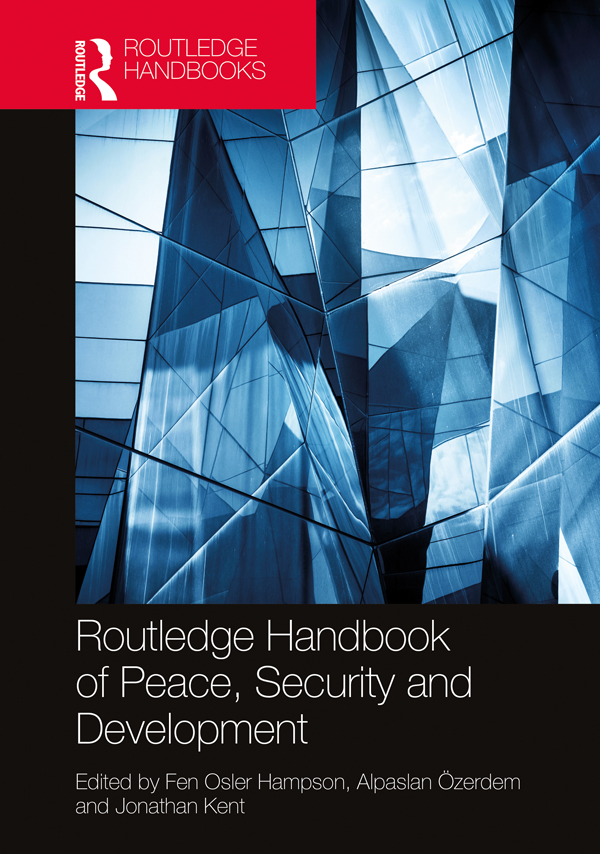
Routledge Handbook of Peace, Security and Development This Handbook offers a comprehensive examination of the peace, security, and development nexus from a global perspective, and investigates the interfaces of these issues in a context characterised by many new challenges. By bringing together more than 40 leading experts and commentators from across the world, the Handbook maps the various research agendas related to these three themes, taking stock of existing work and debates, while outlining areas for further engagement. In doing so, the chapters may serve as a primer for new researchers while also informing the wider scholarly community about the latest research trends and innovations. The volume is split into three thematic parts: Concepts and approaches New drivers of conflict, insecurity, and developmental challenges Actors, institutions, and processes. For ease of use and organisational consistency, each chapter provides readers with an overview of each research area, a review of the state of the literature, a summary of the major debates, and promising directions for future research. This Handbook will be of much interest to students of peace and conflict studies, development studies, security studies, and International Relations. POLITICAL SCIENCE,Peace

For the Sake of Peace Brings together leading scholars from across the globe to reflect on violence, conflict and peace in the USA. POLITICAL SCIENCE,Peace

Mindanao Across more than four decades, the conflict between the national government and Muslim liberation forces in the southern Philippines has killed tens of thousands and displaced millions. Two landmark agreements under the presidency of Benigno S Aquino III — the first in 2012 and the second in 2014 — raised high hopes that peace might finally be on the way. But the peace process stalled, and has yet to regain momentum, after a botched counterterrorism operation in early 2015.This volume provides both in-depth examination of the latest stage of a still-ongoing peace process as well as richly textured analysis of the historical, political, and economic context underlying one of the most enduring conflicts in the world. It is thus an extremely important foundational resource in the continuing quest for peace and prosperity in Mindanao. POLITICAL SCIENCE,Peace

Peacebuilding and Catholic Social Teaching The Roman Catholic Church, with its global reach, centralized organization, and more than 1.4 billion members, could be one of the world’s most significant forces in global peacemaking, and yet its robust tradition of social teaching on peace is not widely known. In Peacebuilding and Catholic Social Teaching, Theodora Hawksley aims to make that tradition better known and understood, and to encourage its continued development in light of the lived experience of Catholics engaged in peacebuilding and conflict transformation worldwide. The first part of this book analyzes the development of Catholic social teaching on peace from the time of the early Church fathers to the present, drawing attention to points of tension and areas in need of development. The second part engages in constructive theological work, exploring how the existing tradition might develop in order to support the efforts of Catholic peacebuilders and respond to the distinctive challenges of contemporary conflict. Peacebuilding and Catholic Social Teaching is one of the first scholarly monographs dedicated exclusively to theology, ethics, and peacebuilding. It will appeal to students and academics who specialize in Catholic social teaching and peacebuilding, to practitioners of Catholic peacebuilding, and to anyone with an interest in religion and peacebuilding more generally. POLITICAL SCIENCE,Peace
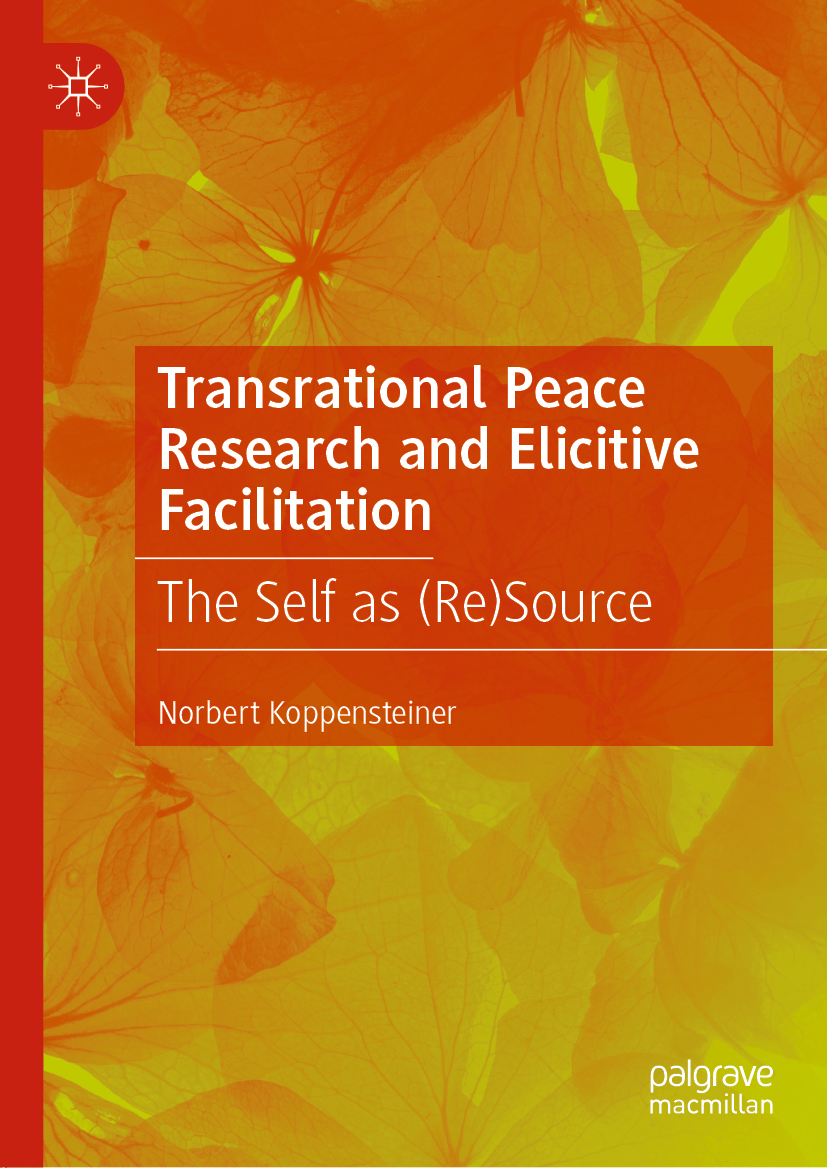
Transrational Peace Research and Elicitive Facilitation This book sheds new light on transrational approaches to peace research and highlights elicitive approaches to facilitation. Rather than encouraging researchers, teachers and practitioners to control and suppress their own positionality, the book argues that they can see themselves as a potential (re)source that can be creatively tapped for their work. Using dance as a central metaphor, it seeks to reposition research and facilitation as a truly experiential process where the entirety of human experiences and epistemologies can be brought into interplay, opening up new sources of knowledge. Providing a cutting-edge theoretical framework and based on his practical experience, the author demonstrates that facilitation and research are not just cognitive, but can also be(come) embodied, emotional, intuitive, relational and spiritual. By proposing a systematic, methodological framework for research and facilitation, the book offers practical guidance for peace practitioners, facilitators and researchers interested in working through all dimensions of their being and engaging with conflict transformation in a holistic way. POLITICAL SCIENCE,Peace
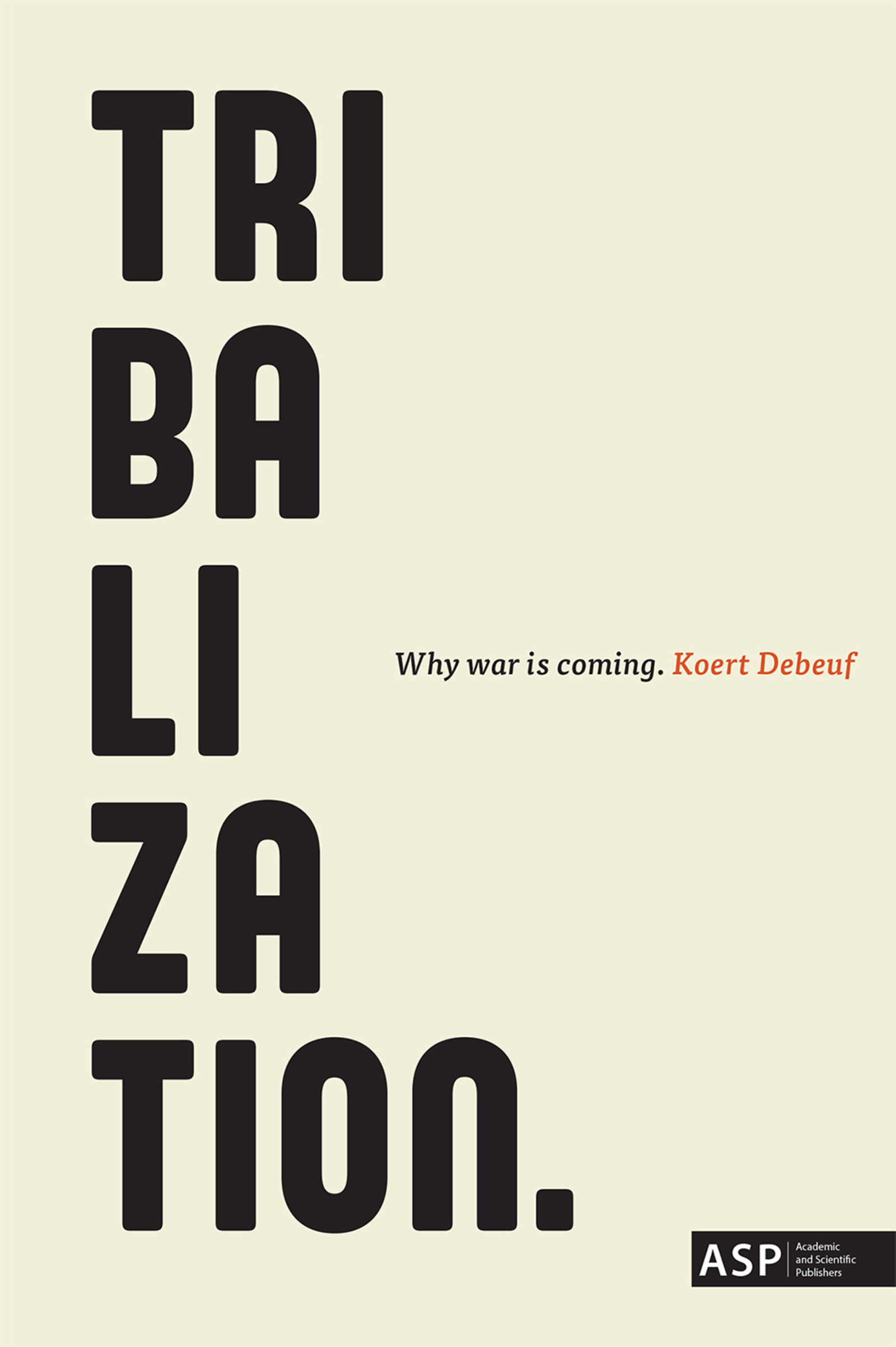
Tribalization War is coming. In Tribalization Koert Debeuf depicts war as an inevitable outcome should the current decreasing of democracy and globalization continue. To describe this worldwide process towards more authoritarian nationalism and fundamentalism The author coins the term tribalization to describe this worldwide process, towards a more authoritarian nationalism and fundamentalism, and reminds his readership of the highly similar 1930s. The election of Donald Trump as president of the United States, the dangerous politics of world leaders like Vladimir Putin, and terrorism are but a few exponents of the worldwide tribalization process that is currently fuelling geopolitics.Leaving traditional explanations aside, Debeuf explains the continuous historical interaction between globalization and tribalization not merely as a economic or political phenomenon. Tribalization is collective psychology, it interrupts globalization when communities react to collective trauma by returning to their mythical, tribal past. Debeuf's insights are based on history and psychology but also on his personal experience during the Arab Revolution, and during his previous political functions, both as an advisor to the former Belgian Prime Minister and as European Union official. POLITICAL SCIENCE,Peace
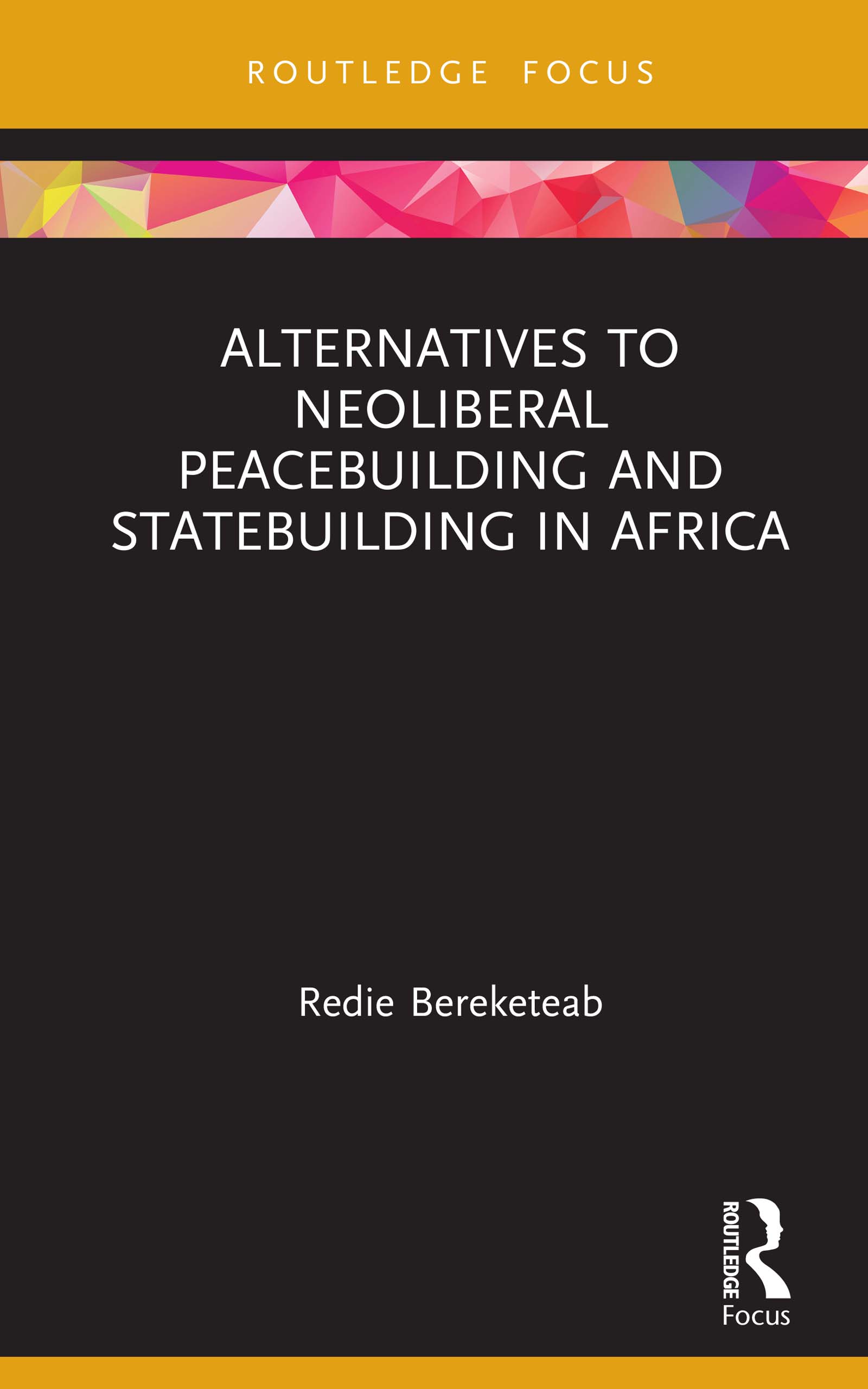
Alternatives to Neoliberal Peacebuilding and Statebuilding in Africa This book critically interrogates the neoliberal peacebuilding and statebuilding model and proposes a popular progressive model centred around the lived realities of African societies. The neoliberal interventionist model assumed prominence and universal hegemony following the demise of state socialism at the end of the Cold War. However, this book argues that it is a primarily short-term, top-down approach that imposes Western norms and values on conflict and post-conflict societies. By contrast, the popular progressive model espoused by this book is based on stringent examination and analysis of the reality of the socio-economic development, structures, institutions, politics and cultures of developing societies. In doing so, it combines bottom-up and top-down, popular and elite, and long-term evolutionary processes of societal construction as a requisite for enduring peacebuilding and statebuilding. By comparing and contrasting the dominant neoliberal peacebuilding and statebuilding model with a popular progressive model, the book seeks to empower locals (both elites and masses) to sit in the driver’s seat and construct their own societies. As such, it is an important contribution to scholars, activists, policymakers, civil society organisations, NGOs and all those who are concerned with peace, stability and development across Africa and other developing countries. POLITICAL SCIENCE,Peace

Building Peace in America Research links a wide and diverse community of scholars, practitioners, and activists towards the common goal of building peace in the United States and play a key role in helping define (and create) the field of “peacebuilding in the US.†POLITICAL SCIENCE,Peace
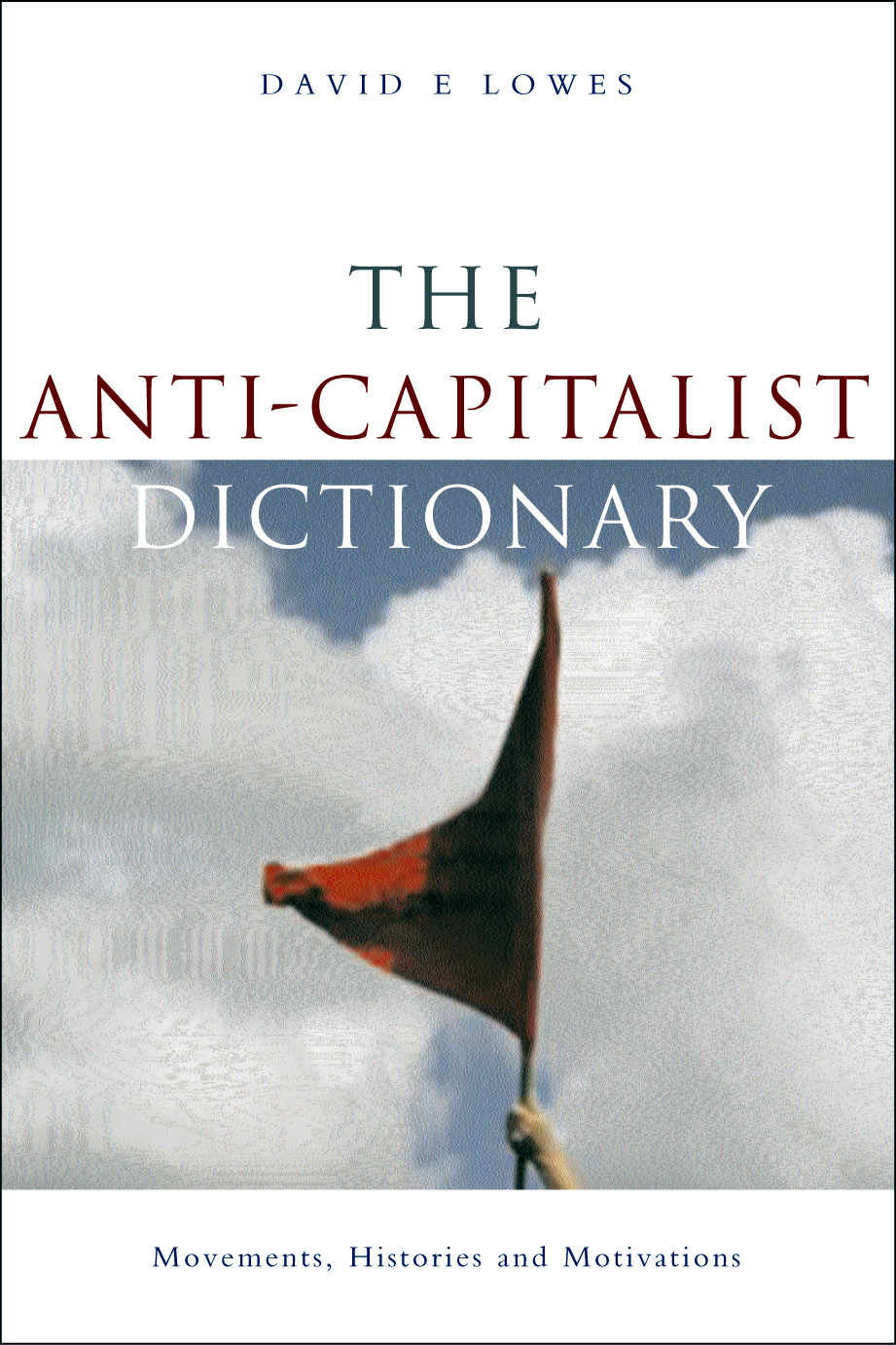
The Anti-Capitalist Dictionary Deals with the ideas and issues that inform modern anti-capitalist activity - activity that has existed in many forms. POLITICAL SCIENCE,Political Economy
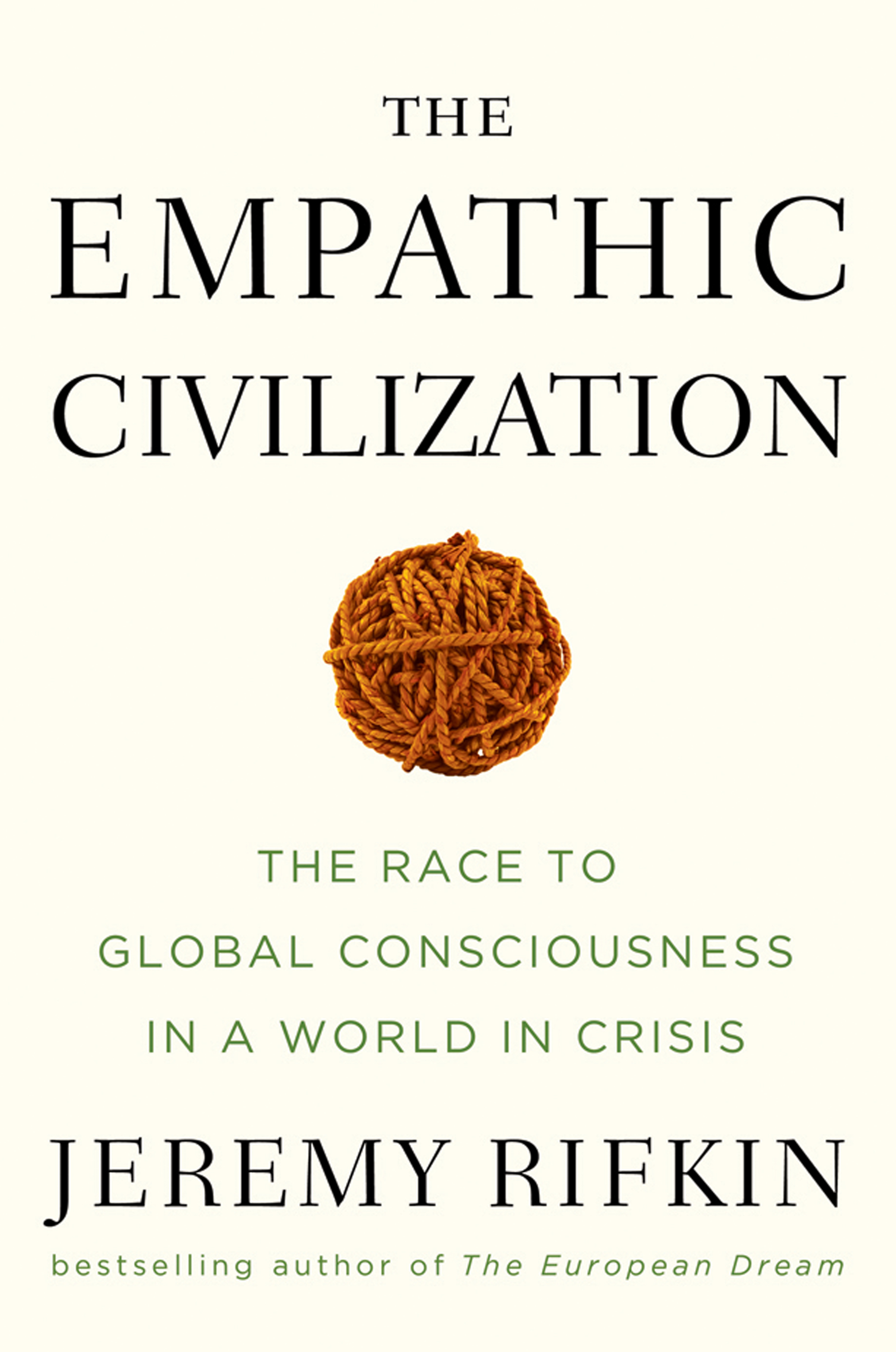
The Empathic Civilization "One of the leading big-picture thinkers of our day" (Utne Reader) delivers his boldest work in this erudite, tough-minded, and far-reaching manifesto. Never has the world seemed so completely united-in the form of communication, commerce, and culture-and so savagely torn apart-in the form of war, financial meltdown, global warming, and even the migration of diseases. No matter how much we put our minds to the task of meeting the challenges of a rapidly globalizing world, the human race seems to continually come up short, unable to muster the collective mental resources to truly "think globally and act locally." In his most ambitious book to date, bestselling social critic Jeremy Rifkin shows that this disconnect between our vision for the world and our ability to realize that vision lies in the current state of human consciousness. The very way our brains are structured disposes us to a way of feeling, thinking, and acting in the world that is no longer entirely relevant to the new environments we have created for ourselves. The human-made environment is rapidly morphing into a global space, yet our existing modes of consciousness are structured for earlier eras of history, which are just as quickly fading away. Humanity, Rifkin argues, finds itself on the cusp of its greatest experiment to date: refashioning human consciousness so that human beings can mutually live and flourish in the new globalizing society. In essence, this shift in consciousness is based upon reaching out to others. But to resist this change in human relations and modes of thinking, Rifkin contends, would spell ineptness and disaster in facing the new challenges around us. As the forces of globalization accelerate, deepen, and become ever more complex, the older faith-based and rational forms of consciousness are likely to become stressed, and even dangerous, as they attempt to navigate a world increasingly beyond their reach and control. Indeed, the emergence of this empathetic consciousness has implications for the future that will likely be as profound and far-reaching as when Enlightenment philosophers upended faith-based consciousness with the canon of reason. POLITICAL SCIENCE,Political Economy
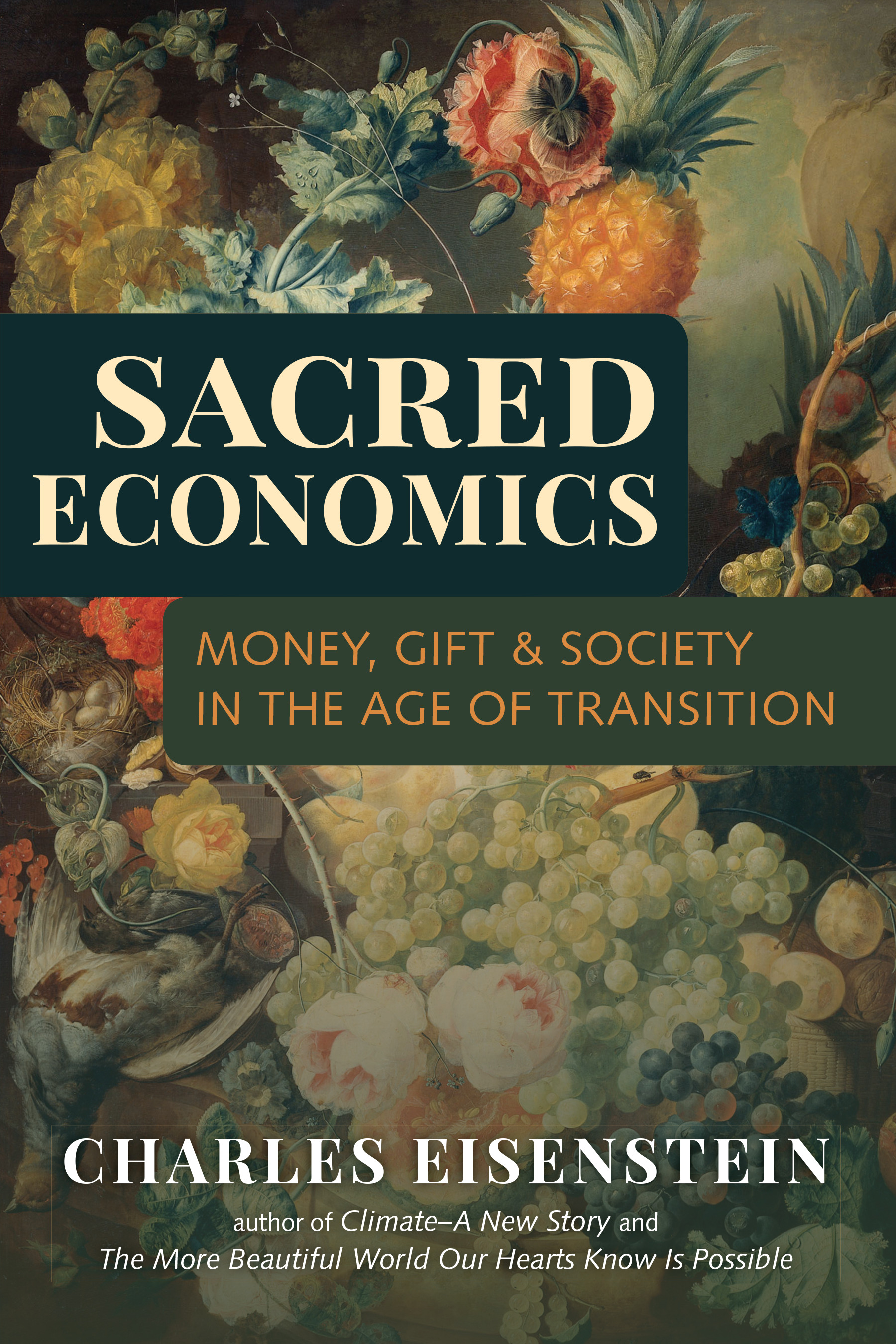
Sacred Economics Sacred Economics traces the history of money from ancient gift economies to modern capitalism, revealing how the money system has contributed to alienation, competition, and scarcity, destroyed community, and necessitated endless growth. Today, these trends have reached their extreme—but in the wake of their collapse, we may find great opportunity to transition to a more connected, ecological, and sustainable way of being. This book is about how the money system will have to change—and is already changing—to embody this transition. A broadly integrated synthesis of theory, policy, and practice, Sacred Economics explores avant-garde concepts of the New Economics, including negative-interest currencies, local currencies, resource-based economics, gift economies, and the restoration of the commons. Author Charles Eisenstein also considers the personal dimensions of this transition, speaking to those concerned with "right livelihood" and how to live according to their ideals in a world seemingly ruled by money. Tapping into a rich lineage of conventional and unconventional economic thought, Sacred Economics presents a vision that is original yet commonsense, radical yet gentle, and increasingly relevant as the crises of our civilization deepen. Sacred Economics official website: http://sacred-economics.com/ POLITICAL SCIENCE,Political Economy
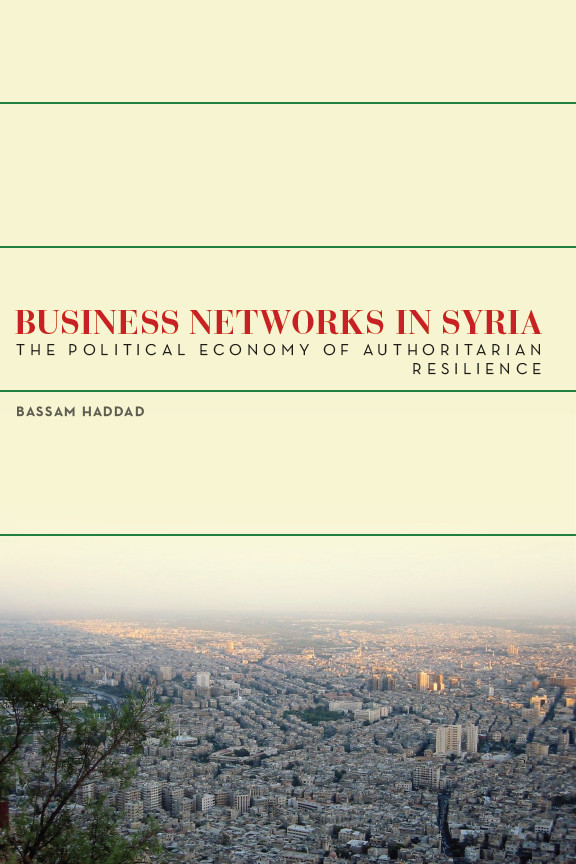
Business Networks in Syria This book examines how state officials and select businessmen come together informally to shape economic development in Syria. POLITICAL SCIENCE,Political Economy
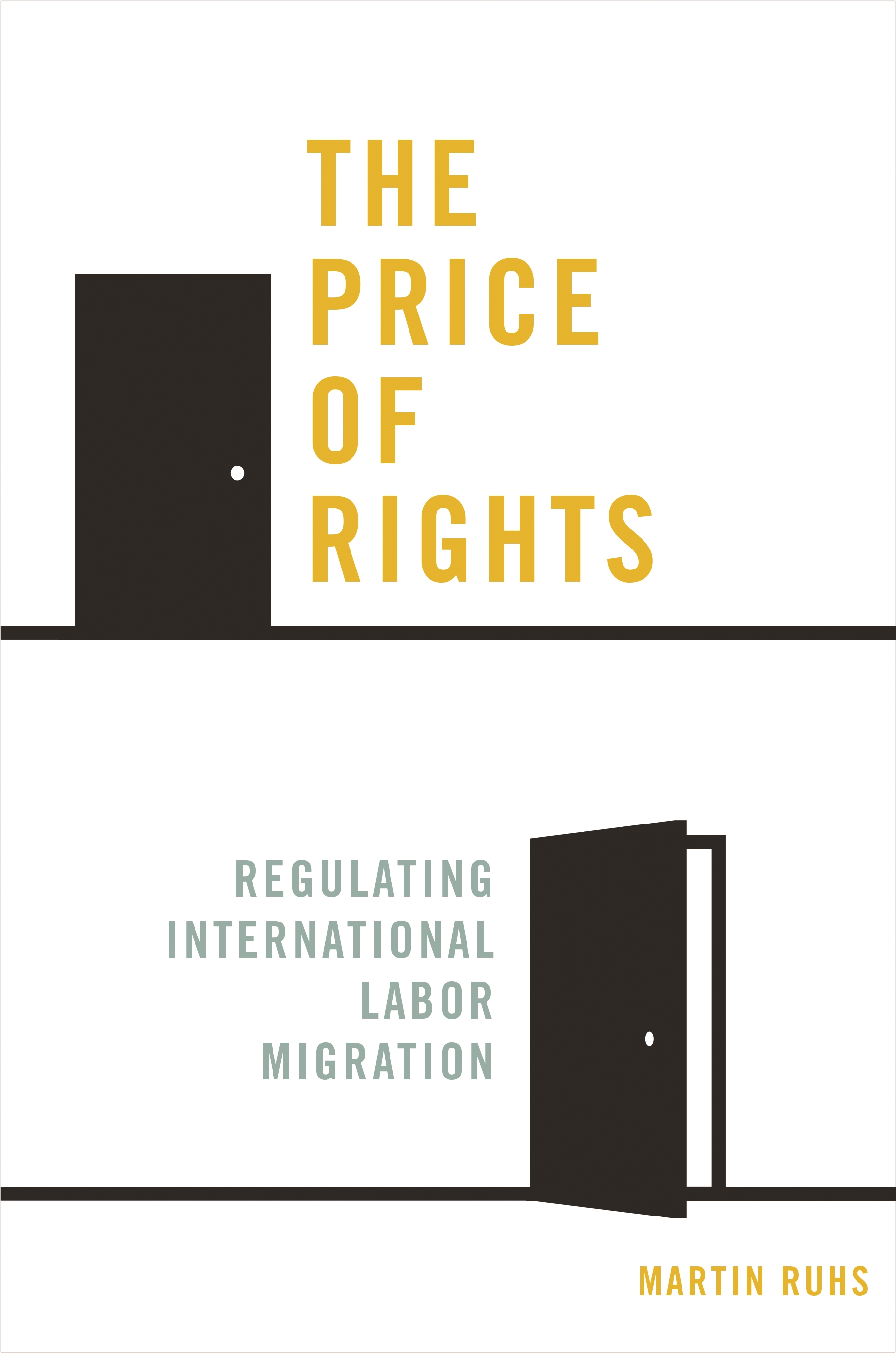
The Price of Rights Many low-income countries and development organizations are calling for greater liberalization of labor immigration policies in high-income countries. At the same time, human rights organizations and migrant rights advocates demand more equal rights for migrant workers. The Price of Rights shows why you cannot always have both. Examining labor immigration policies in over forty countries, as well as policy drivers in major migrant-receiving and migrant-sending states, Martin Ruhs finds that there are trade-offs in the policies of high-income countries between openness to admitting migrant workers and some of the rights granted to migrants after admission. Insisting on greater equality of rights for migrant workers can come at the price of more restrictive admission policies, especially for lower-skilled workers. Ruhs advocates the liberalization of international labor migration through temporary migration programs that protect a universal set of core rights and account for the interests of nation-states by restricting a few specific rights that create net costs for receiving countries. The Price of Rights analyzes how high-income countries restrict the rights of migrant workers as part of their labor immigration policies and discusses the implications for global debates about regulating labor migration and protecting migrants. It comprehensively looks at the tensions between human rights and citizenship rights, the agency and interests of migrants and states, and the determinants and ethics of labor immigration policy. POLITICAL SCIENCE,Political Economy

The Political Economy of Globalization Globalization is transforming the world at an accelerated pace. Integration of the world continues, widening and intensifying international linkages in economic, political and social relations. Liberalization of trade and fmance, lubricated by revolutionary changes in information technology, has resulted in significant economic growth at the global level. On the other hand, the process of globalization is changing the nature of production relations, threatening the traditional roles of the nation-state, and carrying with it far-reaching implications for sustainable growth, development and the environment. Although both developed and developing countries are actively participating in this saga of globalization, nearly ninety countries, as the United Nations' Human Development Report, 1996 indicates, are worse off economically than they were ten years ago, leading to "global polarization" between haves and have nots. The report further indicates that the gap between the per capita incomes of the industrialized world and the developing countries, far from narrowing, has more than tripled during the last thirty years. Further, a majority of the countries benefitting from this globalization drive have seen a rise in inequality and poverty. This failure of market driven globalization to reward the benefits equitably led the United Nations to proclaim 1996 as the International Year for the Eradication of Poverty (IYEP) and the decade of 1997-2006 as the international decade for the eradication of poverty, and to promote "people-centered sustainable development". POLITICAL SCIENCE,Political Economy
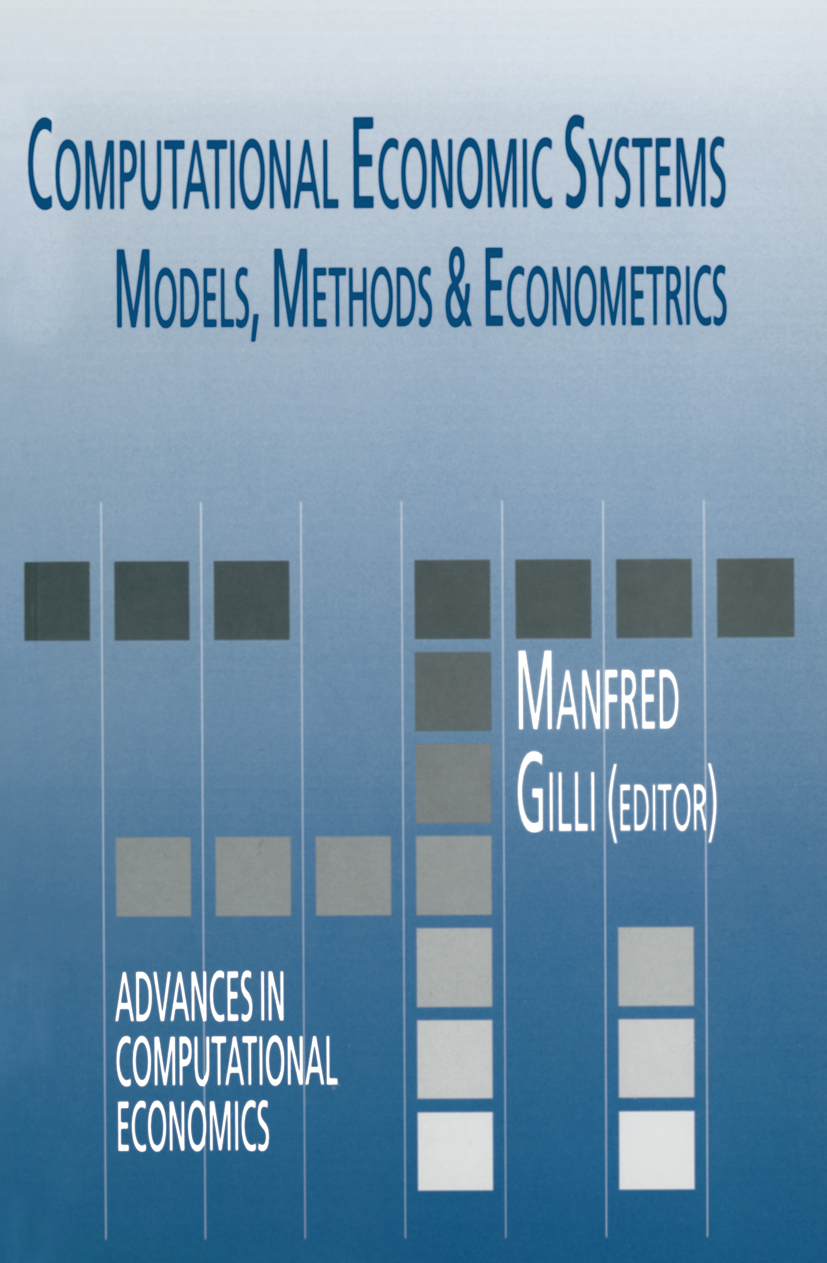
Computational Economic Systems The approach to many problems in economic analysis has changed drastically with the development and dissemination of new and more efficient computational techniques. Computational Economic Systems: Models, Methods & Econometrics presents a selection of papers illustrating the use of new computational methods and computing techniques to solve economic problems. Part I of the volume consists of papers which focus on modelling economic systems, presenting computational methods to investigate the evolution of behavior of economic agents, techniques to solve complex inventory models on a parallel computer and an original approach for the construction and solution of multicriteria models involving logical conditions. Contributions to Part II concern new computational approaches to economic problems. We find an application of wavelets to outlier detection. New estimation algorithms are presented, one concerning seemingly related regression models, a second one on nonlinear rational expectation models and a third one dealing with switching GARCH estimation. Three contributions contain original approaches for the solution of nonlinear rational expectation models. POLITICAL SCIENCE,Political Economy
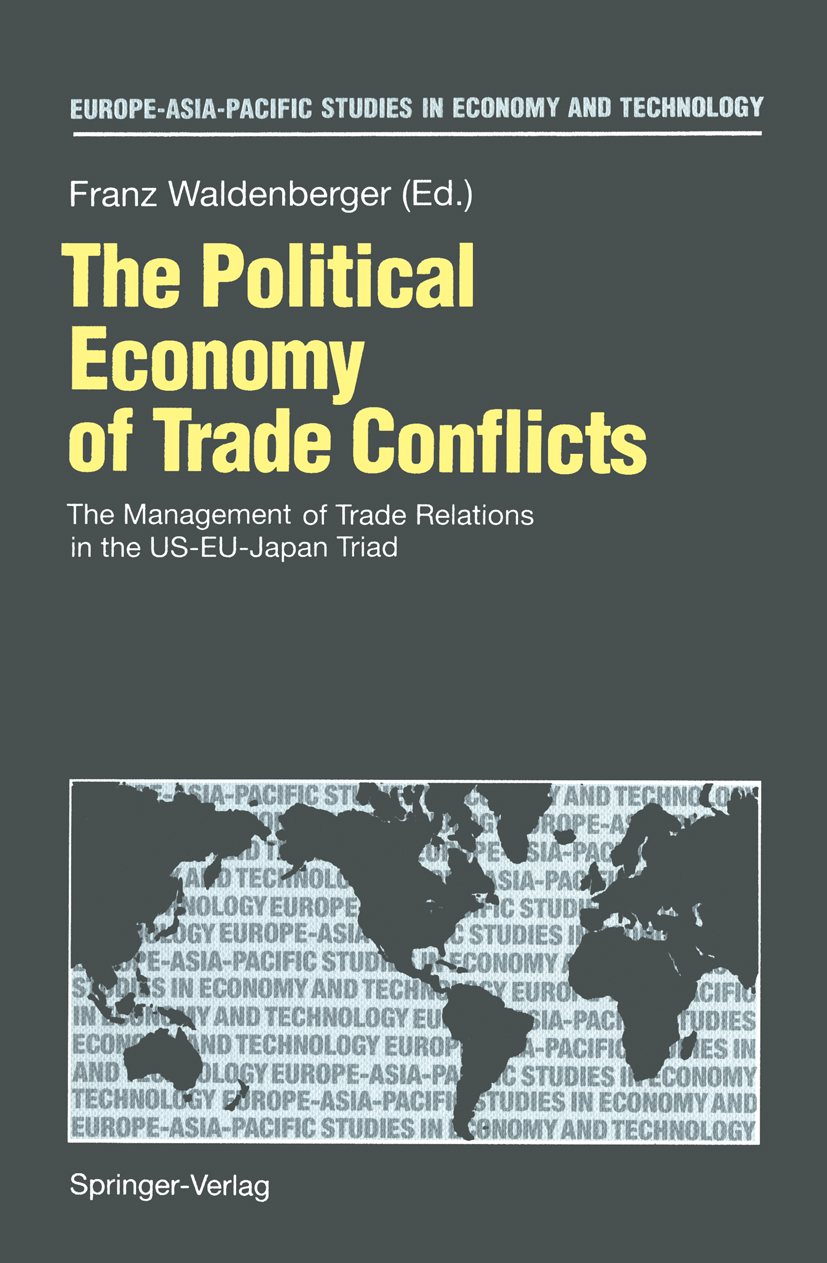
The Political Economy of Trade Conflicts David Ricardo's law of comparative advantage and his finding that free trade increases the wealth of all participating nations is one of the very few economic laws which is accepted by almost all economists. But economic reason and economic policy do not always follow the same path. This especially applies to trade policies. A substantial and growing part of trade between Japan, Europe and the US does not follow the principles of free trade, but is more accurately managed trade. The management of international trade, international trade negotiations, and the political dynamics of trade conflicts create a complex reality which follows its own laws without regard to economic policy prescriptions. This political-economic reality was the subject of the conference 'The Political Economy of Trade Conflicts' organizedjoindy by the German Institute for Japanese Studies and the Friedrich-Ebert-Foundation together with the Institute of Modern Political Science and Economics of Waseda University in December 1993. We present the results of the conference in this reader. Three issues were of special importance: the US-Japanese conflict over the reduction of trade imbalances via quantitative import targets; the liberalization of trade in agricultural products, especially the opening of the Japanese rice market; and the trade tensions between the European Union, the US and Japan in high technology industries. The conference took place immediately before the conclusion of the Uruguay Round, and yet its subject continues to be of high political importance. In early 1994, the US-Japan conflict around quantitative import targets became more tense. POLITICAL SCIENCE,Political Economy
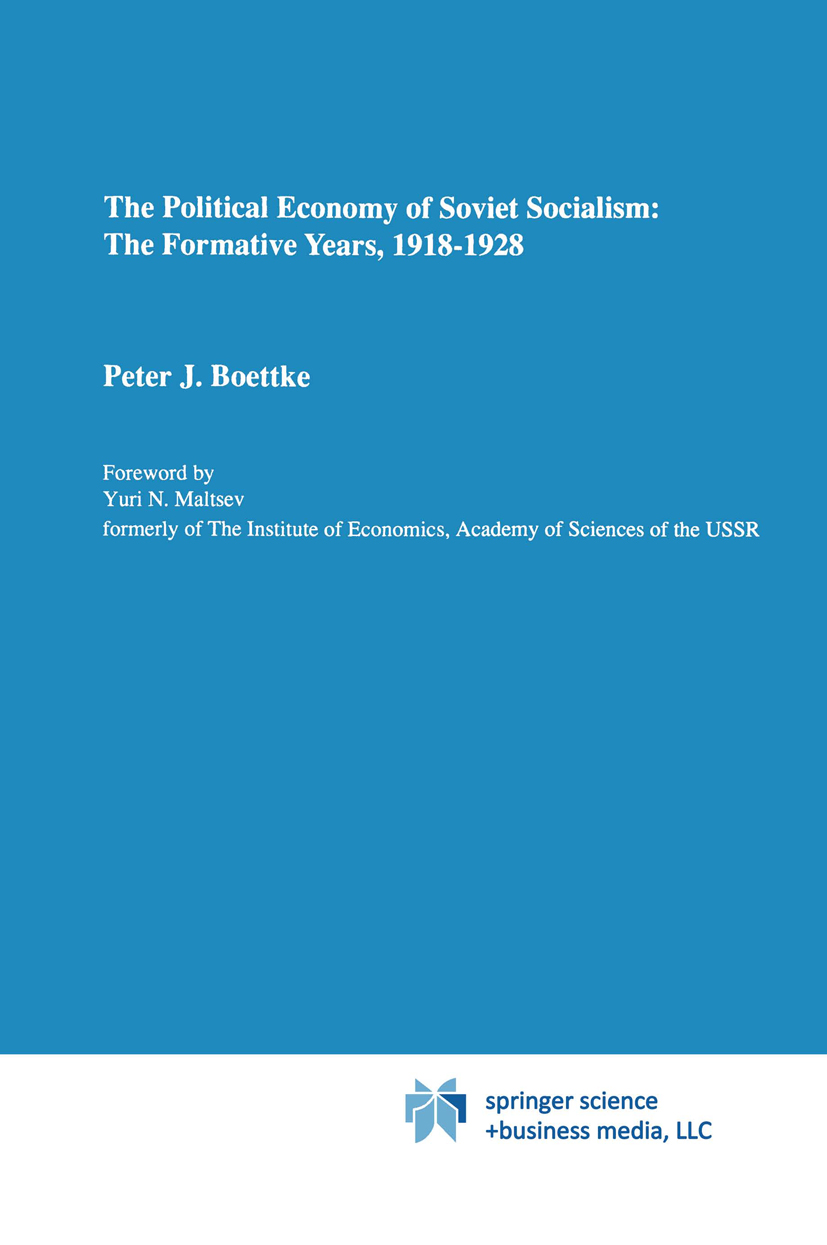
The Political Economy of Soviet Socialism by Yuri N. Maltsev formerly of the Institute of Economics, Academy of Sciences of the USSR The following study on the history of Soviet economic thought during the first years after the Bolshevik Revolution of 1917 is much more than the regular academic scribble on this turbulent period of modem history. It is a systematic treatise on economic theory. Interdisciplinary in nature, it discusses the central problems of political economy and provides the serious reader with deep insight and complete understanding of the greatest event of the twentieth century: the rise and fall of communism. The foundations ofthe economic system that we see today in a state offull-fledged crisis were laid during the first ten years of the communist regime in the Soviet Union. The symptoms and manifestations of this crisis have been cogently de scribed elsewhere. The author should be credited for his appraisal and illumination of the real causes, both economic and moral, of the great drama of our times. At the end of the treatise, it is absolutely clear that only by means of economic theory is it possible to organize and interpret seemingly chaotic historical and statistical data, isolated facts, and opinions that constitute the mass media's coverage of an overly complex array of events in the USSR. POLITICAL SCIENCE,Political Economy
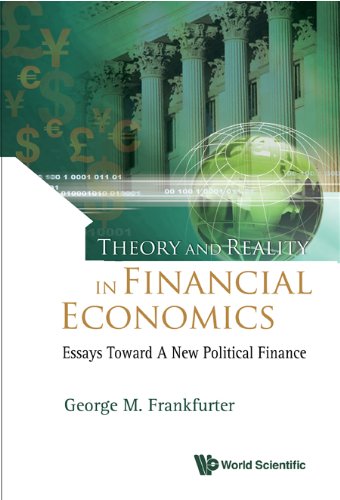
Theory And Reality In Financial Economics The current literature on financial economics is dominated by neoclassical dogma and, supposedly, the notion of value-neutrality. However, the failure of neoclassical economics to deal with real financial phenomena suggests that this might be too simplistic of an approach.This book consists of a collection of essays dealing with financial markets' imperfections, and the inability of neoclassical economics to deal with such imperfections. Its central argument is that financial economics, as based on the tenets of neoclassical economics, cannot answer or solve the real-life problems that people face. It also shows the direct relationship between economics and politics — something that is usually denied in academic models, given that science is supposed to be value-neutral. In this thought-provoking and avant-garde book, the author not only exposes what has gone wrong, but also suggests reforms to both the academic and the political-economic systems that might help make markets fair rather than efficient. Drawing on interdisciplinary fields, this book will appeal to readers who are interested in finance, economics, business, the political economy and philosophy. POLITICAL SCIENCE,Political Economy

Four Futures Capitalism is going to end Peter Frase argues that increasing automation and a growing scarcity of resources, thanks to climate change, will bring it all tumbling down. In Four Futures, Frase imagines how this post-capitalist world might look, deploying the tools of both social science and speculative fiction to explore what communism, rentism, socialism and exterminism might actually entail. Could the current rise of real-life robocops usher in a world that resembles Ender’s Game? And sure, communism will bring an end to material scarcities and inequalities of wealth—but there’s no guarantee that social hierarchies, governed by an economy of “likes,” wouldn’t rise to take their place. A whirlwind tour through science fiction, social theory and the new technologies already shaping our lives, Four Futures is a balance sheet of the socialisms we may reach if a resurgent Left is successful, and the barbarisms we may be consigned to if those movements fail. POLITICAL SCIENCE,Political Economy
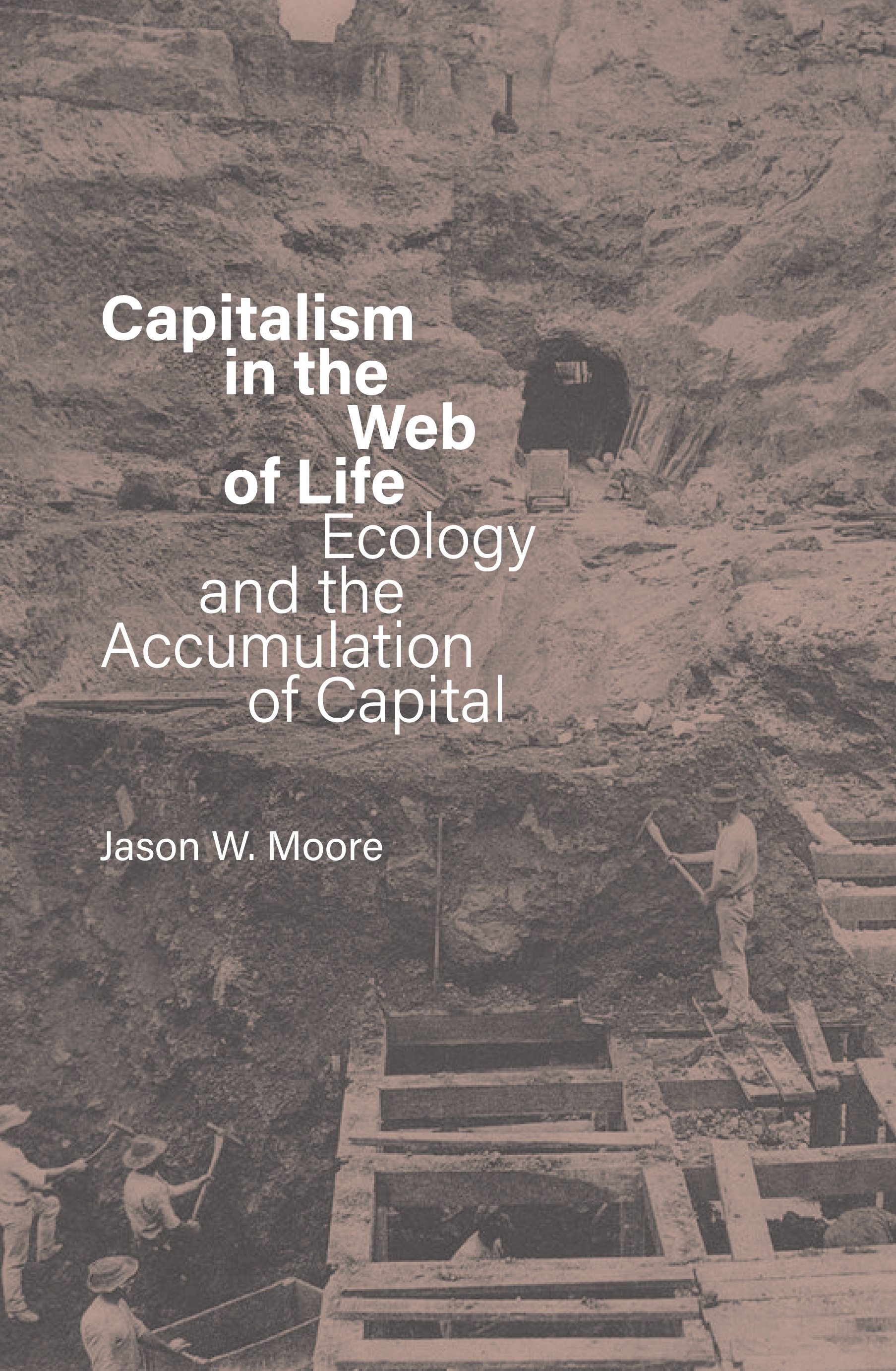
Capitalism in the Web of Life Finance. Climate. Food. Work. How are the crises of the twenty-first century connected? In Capitalism in the Web of Life, Jason W. Moore argues that the sources of today’s global turbulence have a common cause: capitalism as a way of organizing nature, including human nature. Drawing on environmentalist, feminist, and Marxist thought, Moore offers a groundbreaking new synthesis: capitalism as a “world-ecology” of wealth, power, and nature. Capitalism’s greatest strength—and the source of its problems—is its capacity to create Cheap Natures: labor, food, energy, and raw materials. That capacity is now in question. Rethinking capitalism through the pulsing and renewing dialectic of humanity-in-nature, Moore takes readers on a journey from the rise of capitalism to the modern mosaic of crisis. Capitalism in the Web of Life shows how the critique of capitalism-in-nature—rather than capitalism and nature—is key to understanding our predicament, and to pursuing the politics of liberation in the century ahead. POLITICAL SCIENCE,Political Economy

Money Logging Money Logging investigates what Gordon Brown has called ìprobably the biggest environmental crime of our timesîóthe massive destruction of the Borneo rainforest by Malaysian loggers. Historian and campaigner Lukas Straumann goes in search not only of the lost forests and the people who used to call them home, but also the network of criminals who have earned billions through illegal timber sales and corruption. Straumann singles out Abdul Taib Mahmud, current governor of the Malaysian state of Sarawak, as the kingpin of this Asian timber mafia, while he shows that TaibÃs familyówith the complicity of global financial institutionsó have profited to the tune of 15 billion US dollars. Money Logging is a story of a people who have lost their ancient paradise to a wasteland of oil palm plantations, pollution, and corruptionóand how they hope to take it back. POLITICAL SCIENCE,Political Economy
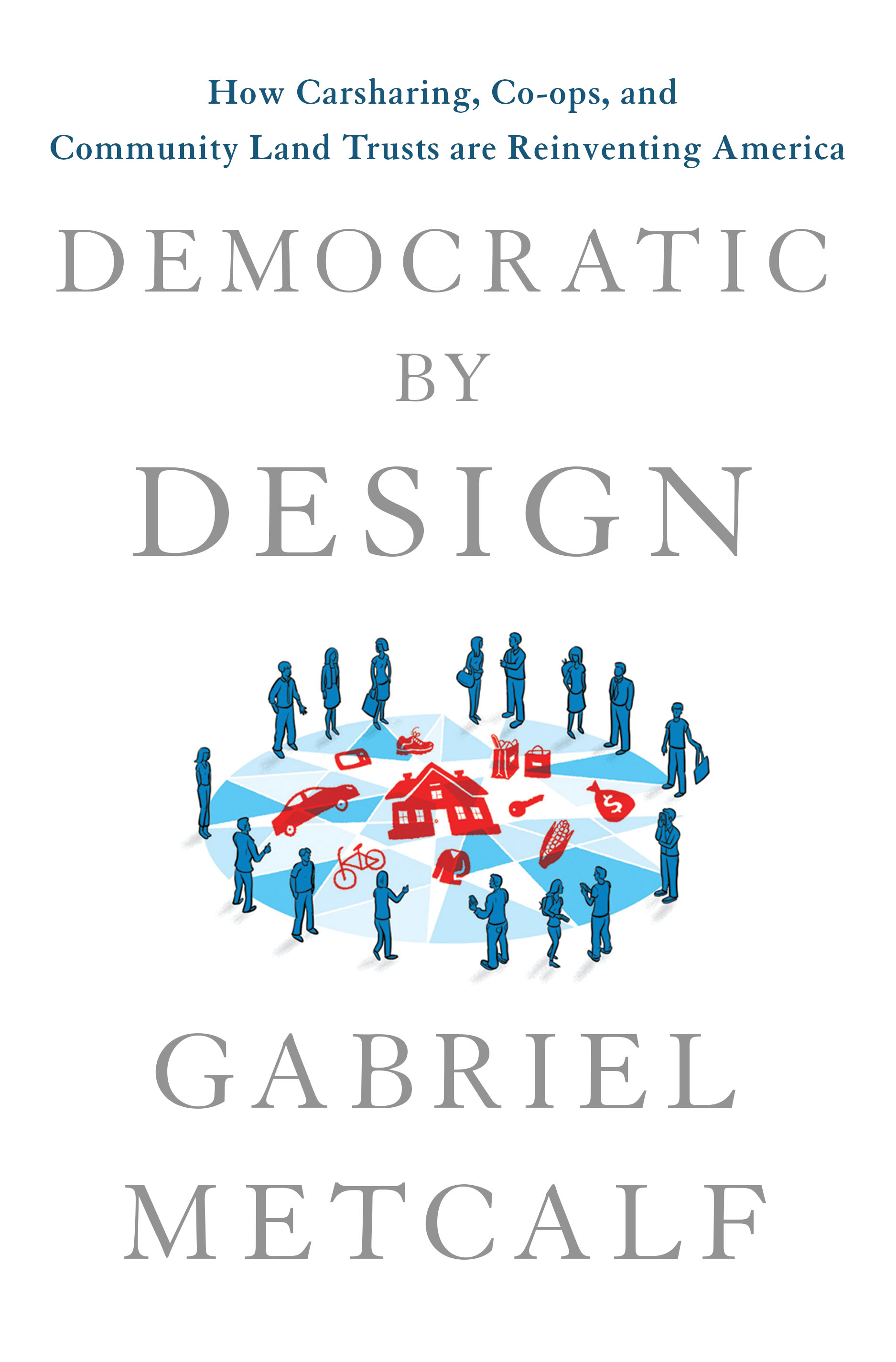
Democratic by Design A look at the burgeoning movement towards "alternative institutions," and how it can level the American playing field POLITICAL SCIENCE,Political Economy
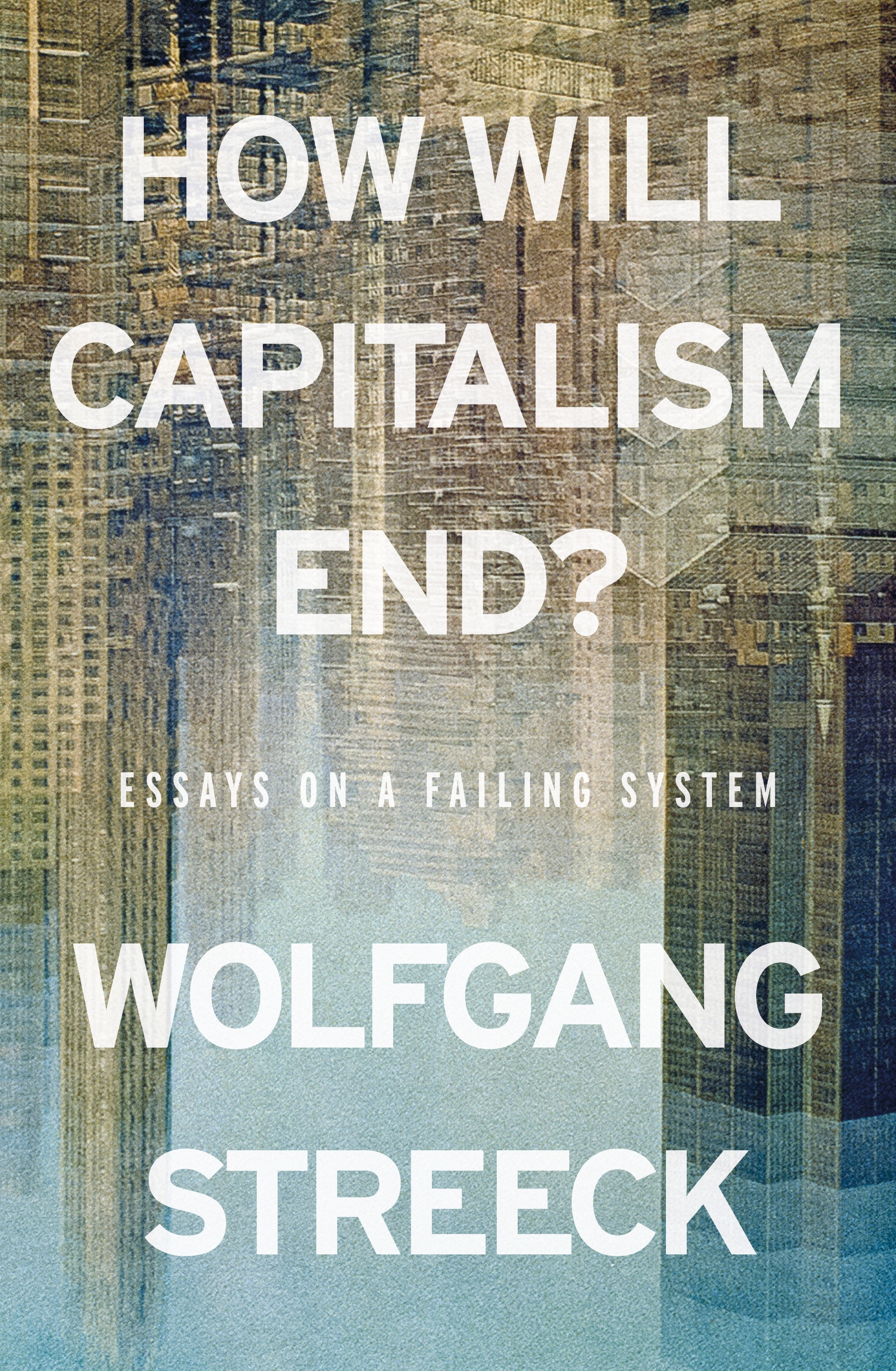
How Will Capitalism End? The provocative political thinker asks if it will be with a bang or a whimper After years of ill health, capitalism is now in a critical condition. Growth has given way to stagnation; inequality is leading to instability; and confidence in the money economy has all but evaporated. In How Will Capitalism End?, the acclaimed analyst of contemporary politics and economics Wolfgang Streeck argues that the world is about to change. The marriage between democracy and capitalism, ill-suited partners brought together in the shadow of World War Two, is coming to an end. The regulatory institutions that once restrained the financial sector’s excesses have collapsed and, after the final victory of capitalism at the end of the Cold War, there is no political agency capable of rolling back the liberalization of the markets. Ours has become a world defined by declining growth, oligarchic rule, a shrinking public sphere, institutional corruption and international anarchy, and no cure to these ills is at hand. POLITICAL SCIENCE,Political Economy
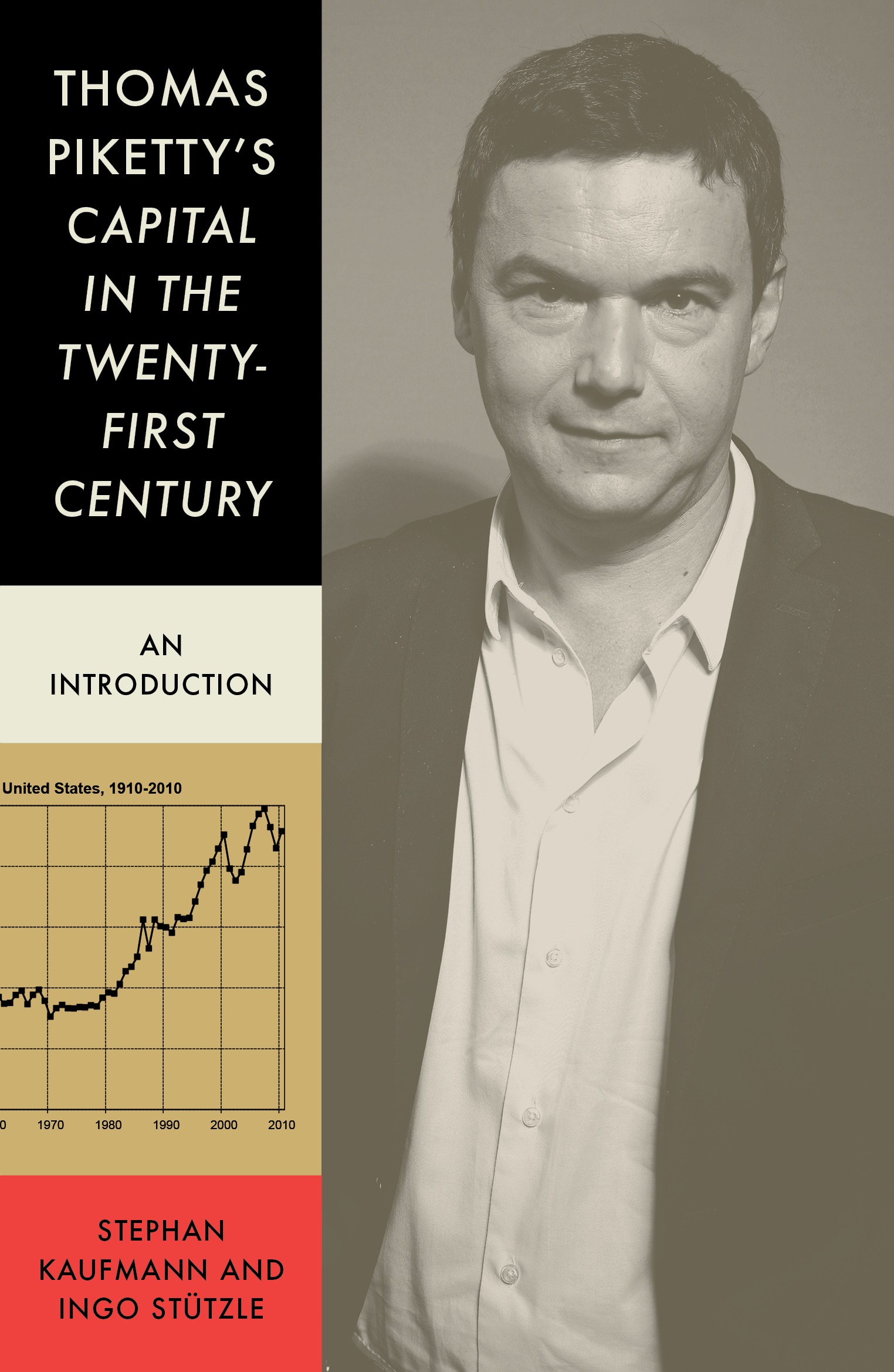
Thomas Piketty's Capital in the Twenty-First Century An introduction to Thomas Piketty’s monumental work US Nobel Prize–winner Paul Krugman described Thomas Piketty’s Capital in the Twenty-First Century as “perhaps the most important book of the last decade.” It has sparked major international debates, dominated bestseller lists and generated a level of enthusiasm—as well as intense criticism—in a way no other economic or sociological work has in a long time. Piketty has been described as a new Karl Marx and placed in the same league as the economist John Maynard Keynes. The “rock star economist’s” underlying thesis is that inequality under capitalism has reached dramatic levels in the last few decades and continues to grow—and that this is not by chance. A small elite is making itself richer and richer and acquiring everincreasing levels of power. Given the sensational reception of Piketty’s not-so-easily digested 800-page study, the question as to where the hype around the book comes from deserves to be asked. What does it get right? And what should we make of it—both of the book itself and of the criticism it has received? This introduction lays out the argument of Piketty’s monumental work in a compact and understandable format, while also investigating the controversies Piketty has stirred up. In addition, the two authors demonstrate the limits, contradictions and errors of the so-called Piketty revolution. POLITICAL SCIENCE,Political Economy
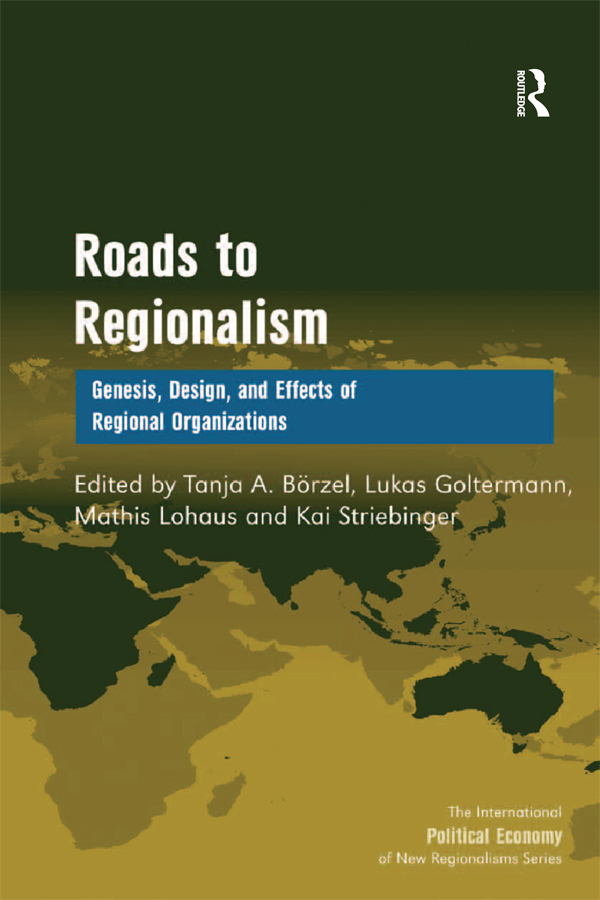
Roads to Regionalism Over the past few decades states all around the globe have intensified institutionalized cooperation at the regional level. To deepen our understanding of state-led regionalism, the authors use an analytical framework comprising four main strands. First, they describe and explain the genesis and growth of regional organizations. Second, they account for institutional design, looking at important similarities and differences. Third, they examine the interaction between organizations and member states in an attempt to reveal factors that shape the level of commitment to and compliance with regional initiatives. Finally, they consider the impact of regional organizations on their member states. They conclude by providing a foundation for future research on the dynamic development of regionalism. POLITICAL SCIENCE,Political Economy

The Political Economy of the Special Relationship How America's global financial power was created and shaped through its special relationship with Britain The rise of global finance in the latter half of the twentieth century has long been understood as one chapter in a larger story about the postwar growth of the United States. The Political Economy of the Special Relationship challenges this popular narrative. Revealing the Anglo-American origins of financial globalization, Jeremy Green sheds new light on Britain’s hugely significant, but often overlooked, role in remaking international capitalism alongside America. Drawing from new archival research, Green questions the conventional view of international economic history as a series of cyclical transitions among hegemonic powers. Instead, he explores the longstanding interactive role of private and public financial institutions in Britain and the United States—most notably the close links between their financial markets, central banks, and monetary and fiscal policies. He shows that America’s unparalleled post-WWII financial power was facilitated, and in important ways constrained, by British capitalism, as the United States often had to work with and through British politicians, officials, and bankers to achieve its vision of a liberal economic order. Transatlantic integration and competition spurred the rise of the financial sector, an increased reliance on debt, a global easing of regulation, the ascendance of monetarism, and the transition to neoliberalism. From the gold standard to the recent global financial crisis and beyond, The Political Economy of the Special Relationship recasts the history of global finance through the prism of Anglo-American development. POLITICAL SCIENCE,Political Economy
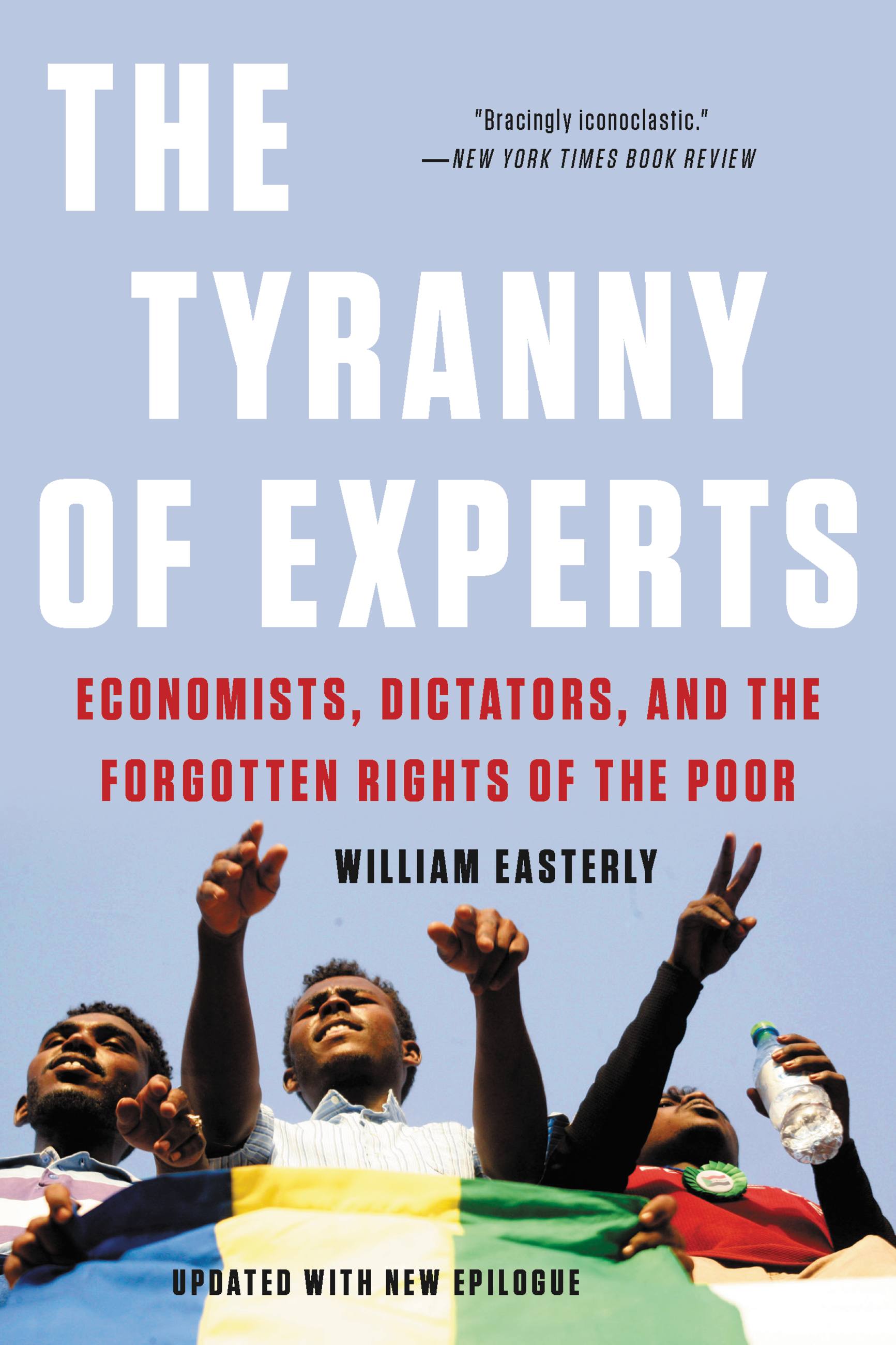
The Tyranny of Experts "Bracingly iconoclastic." -- New York Times Book Review In The Tyranny of Experts, renowned economist William Easterly examines our failing efforts to fight global poverty, and argues that the "expert approved" top-down approach to development has not only made little lasting progress, but has proven a convenient rationale for decades of human rights violations perpetrated by colonialists, postcolonial dictators, and US and UK foreign policymakers seeking autocratic allies. Demonstrating how our traditional antipoverty tactics have both trampled the freedom of the world's poor and suppressed a vital debate about alternative approaches to solving poverty, Easterly presents a devastating critique of the blighted record of authoritarian development. In this masterful work, Easterly reveals the fundamental errors inherent in our traditional approach and offers new principles for Western agencies and developing countries alike: principles that, because they are predicated on respect for the rights of poor people, have the power to end global poverty once and for all. POLITICAL SCIENCE,Political Economy
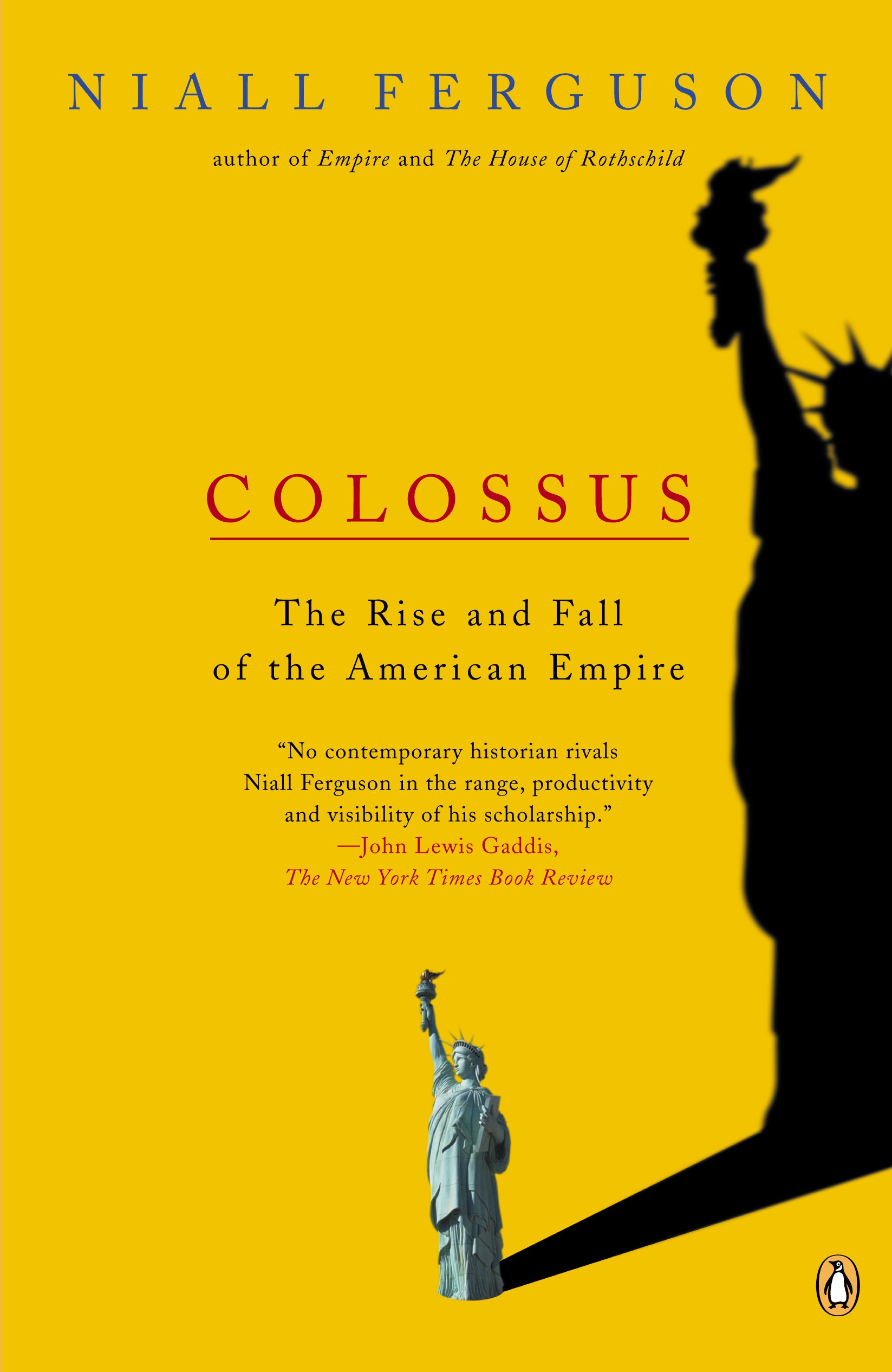
Colossus Is America an empire? Certainly not, according to our government. Despite the conquest of two sovereign states in as many years, despite the presence of more than 750 military installations in two thirds of the world’s countries and despite his stated intention "to extend the benefits of freedom...to every corner of the world," George W. Bush maintains that "America has never been an empire." "We don’t seek empires," insists Defense Secretary Rumsfeld. "We’re not imperialistic."Nonsense, says Niall Ferguson. In Colossus he argues that in both military and economic terms America is nothing less than the most powerful empire the world has ever seen. Just like the British Empire a century ago, the United States aspires to globalize free markets, the rule of law, and representative government. In theory it’s a good project, says Ferguson. Yet Americans shy away from the long-term commitments of manpower and money that are indispensable if rogue regimes and failed states really are to be changed for the better. Ours, he argues, is an empire with an attention deficit disorder, imposing ever more unrealistic timescales on its overseas interventions. Worse, it’s an empire in denial—a hyperpower that simply refuses to admit the scale of its global responsibilities. And the negative consequences will be felt at home as well as abroad. In an alarmingly persuasive final chapter Ferguson warns that this chronic myopia also applies to our domestic responsibilities. When overstretch comes, he warns, it will come from within—and it will reveal that more than just the feet of the American colossus is made of clay. POLITICAL SCIENCE,Political Economy

Circles of Compensation Japan grew explosively and consistently for more than a century, from the Meiji Restoration until the collapse of the economic bubble in the early 1990s. Since then, it has been unable to restart its economic engine and respond to globalization. How could the same political–economic system produce such strongly contrasting outcomes? This book identifies the crucial variables as classic Japanese forms of socio-political organization: the "circles of compensation." These cooperative groupings of economic, political, and bureaucratic interests dictate corporate and individual responses to such critical issues as investment and innovation; at the micro level, they explain why individuals can be decidedly cautious on their own, yet prone to risk-taking as a collective. Kent E. Calder examines how these circles operate in seven concrete areas, from food supply to consumer electronics, and deals in special detail with the influence of Japan's changing financial system. The result is a comprehensive overview of Japan's circles of compensation as they stand today, and a road map for broadening them in the future. POLITICAL SCIENCE,Political Economy
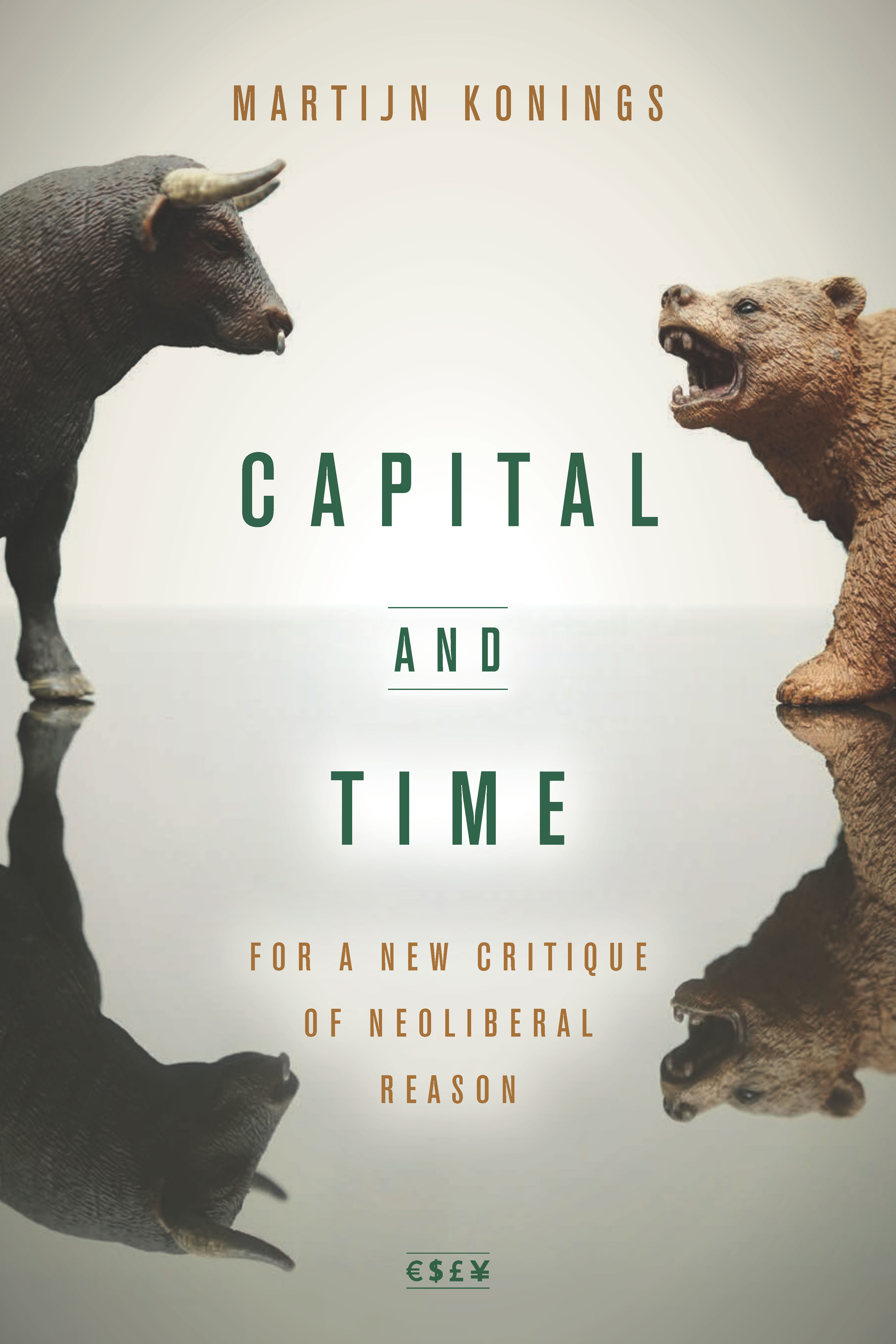
Capital and Time This book moves beyond mere denouncements of financial speculation to rethink the role of uncertainty, contingency, and time in contemporary capitalism. POLITICAL SCIENCE,Political Economy
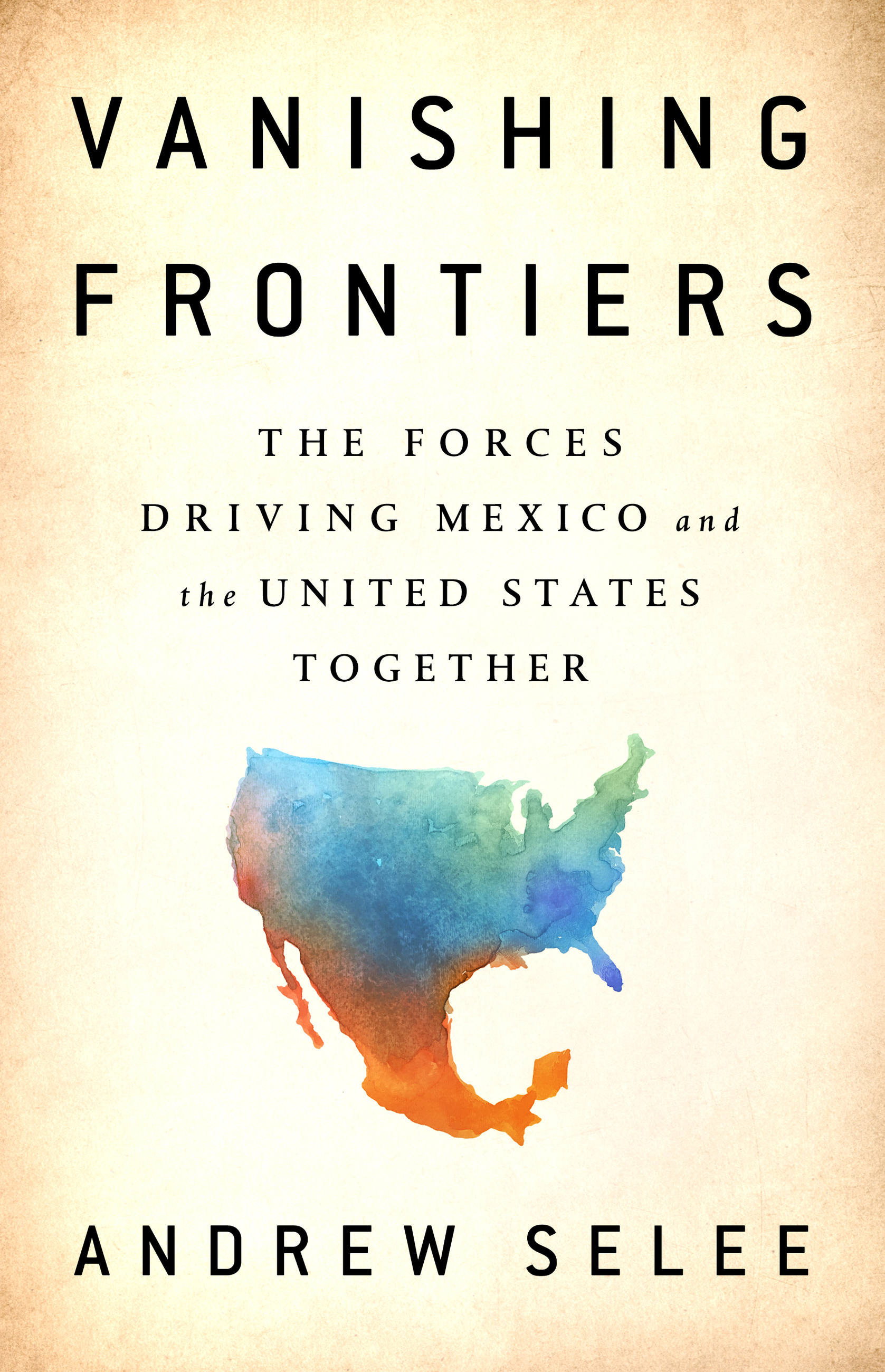
Vanishing Frontiers There may be no story today with a wider gap between fact and fiction than the relationship between the United States and Mexico. Wall or no wall, deeply intertwined social, economic, business, cultural, and personal relationships mean the US-Mexico border is more like a seam than a barrier, weaving together two economies and cultures. Mexico faces huge crime and corruption problems, but its remarkable transformation over the past two decades has made it a more educated, prosperous, and innovative nation than most Americans realize. Through portraits of business leaders, migrants, chefs, movie directors, police officers, and media and sports executives, Andrew Selee looks at this emerging Mexico, showing how it increasingly influences our daily lives in the United States in surprising ways -- the jobs we do, the goods we consume, and even the new technology and entertainment we enjoy. From the Mexican entrepreneur in Missouri who saved the US nail industry, to the city leaders who were visionary enough to build a bridge over the border fence so the people of San Diego and Tijuana could share a single international airport, to the connections between innovators in Mexico's emerging tech hub in Guadalajara and those in Silicon Valley, Mexicans and Americans together have been creating productive connections that now blur the boundaries that once separated us from each other. POLITICAL SCIENCE,Political Economy
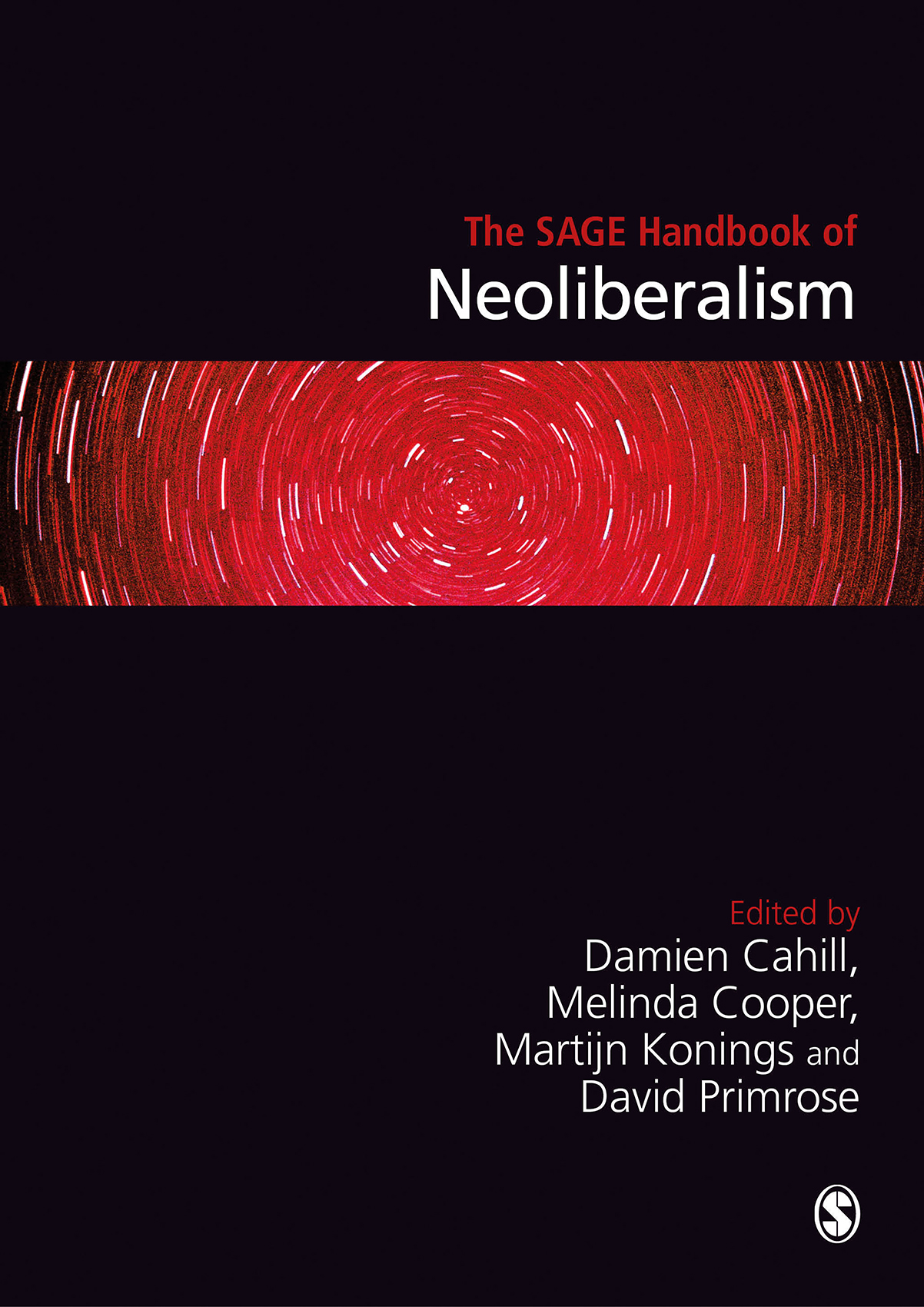
The SAGE Handbook of Neoliberalism Across seven sections - including Neoliberal Economies, The State and Regulation, and Neoliberalism in Crisis - this resource brings together a global team of experts to explore the cutting edge of contemporary scholarship in the field POLITICAL SCIENCE,Political Economy

Giants A look at the top 300 most powerful players in world capitalism, who are at the controls of our economic future. Who holds the purse strings to the majority of the world's wealth? There is a new global elite at the controls of our economic future, and here former Project Censored director and media monitoring sociologist Peter Phillips unveils for the general reader just who these players are. The book includes such power players as Mark Zuckerberg, Bill Gates, Jeff Bezos, Jamie Dimon, and Warren Buffett. As the number of men with as much wealth as half the world fell from sixty-two to just eight between January 2016 and January 2017, according to Oxfam International, fewer than 200 super-connected asset managers at only 17 asset management firms—each with well over a trillion dollars in assets under management—now represent the financial core of the world's transnational capitalist class. Members of the global power elite are the management—the facilitators—of world capitalism, the firewall protecting the capital investment, growth, and debt collection that keeps the status quo from changing. Each chapter in Giants identifies by name the members of this international club of multi-millionaires, their 17 global financial companies—and including NGOs such as the Group of Thirty and the Trilateral Commission—and their transnational military protectors, so the reader, for the first time anywhere, can identify who constitutes this network of influence, where the wealth is concentrated, how it suppresses social movements, and how it can be redistributed for maximum systemic change. POLITICAL SCIENCE,Political Economy
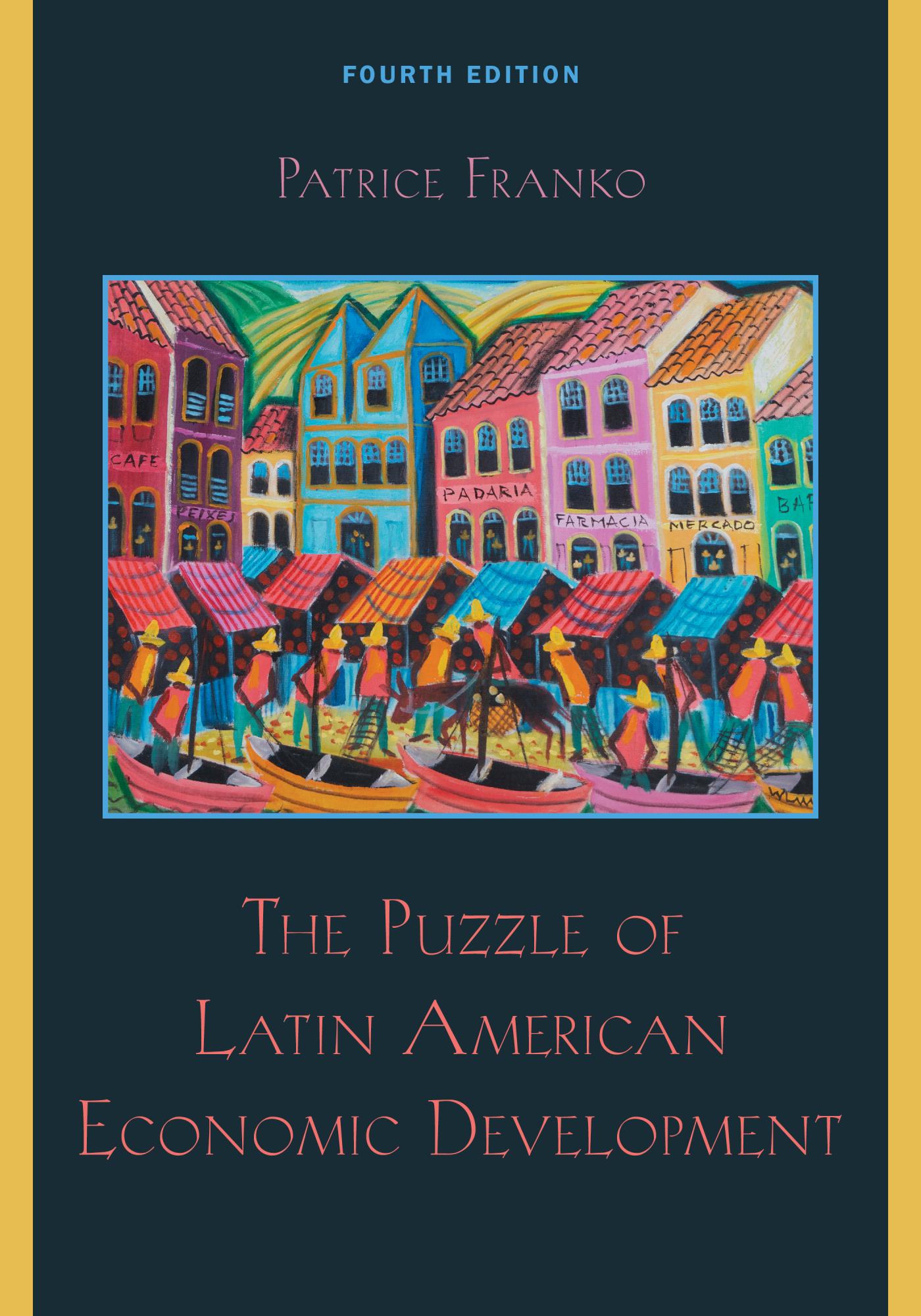
The Puzzle of Latin American Economic Development Thoroughly revised and updated, this foundational text provides the basic economic tools for students to understand the problems facing the countries of Latin America. In the fourth edition, Patrice Franko analyzes challenges to the neoliberal model of development and highlights recent macroeconomic changes in the region. POLITICAL SCIENCE,Political Economy
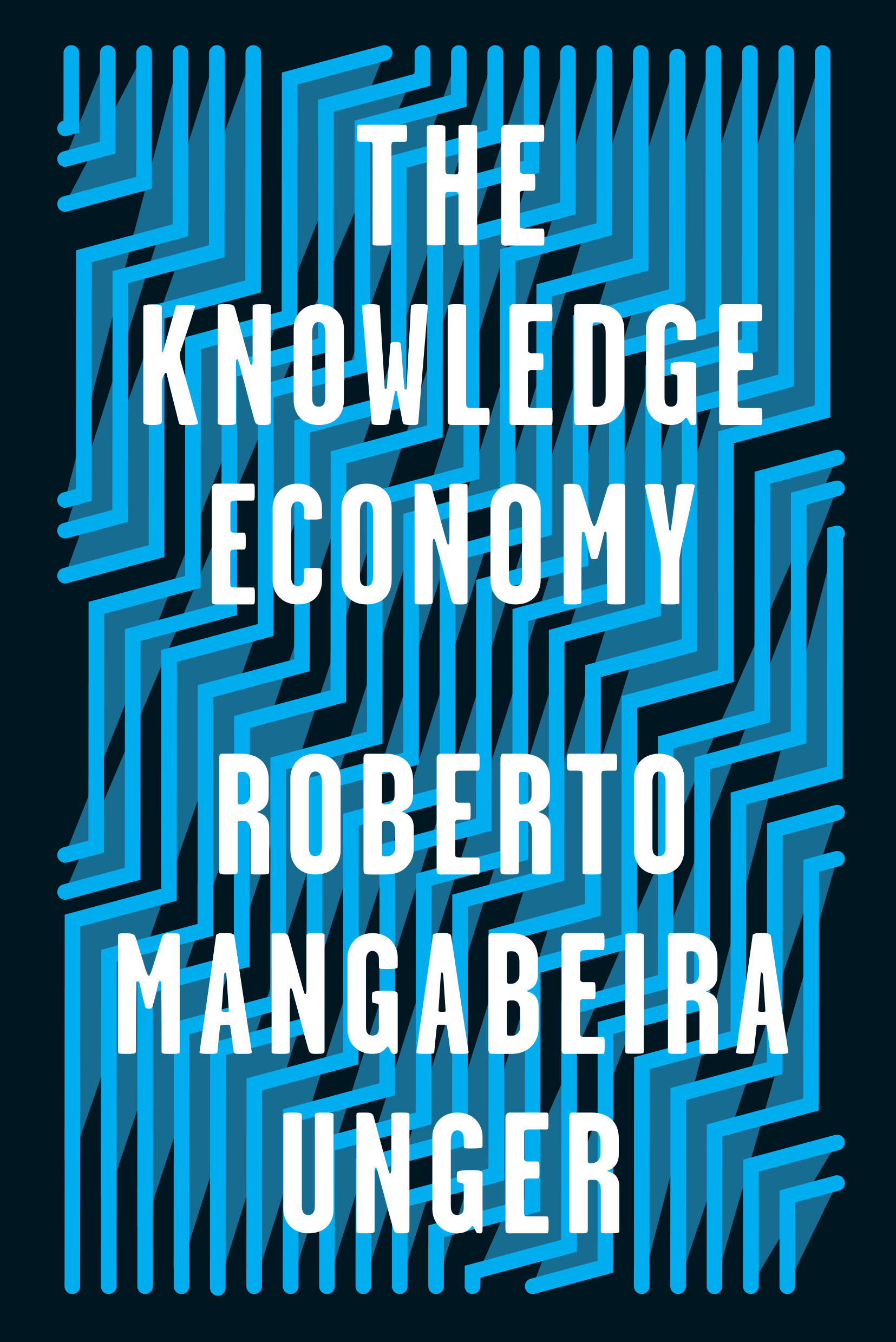
The Knowledge Economy Revolutionary account of the transformative potential of the knowledge economy Adam Smith and Karl Marx recognized that the best way to understand the economy is to study the most advanced practice of production. Today that practice is no longer conventional manufacturing: it is the radically innovative vanguard known as the knowledge economy. In every part of the production system it remains a fringe excluding the vast majority of workers and businesses. This book explores the hidden nature of the knowledge economy and its possible futures. The confinement of the knowledge economy to these insular vanguards has become a driver of economic stagnation and inequality throughout the world. Traditional mass production has stopped working as a shortcut to economic growth. But the alternative—a deepened and socially inclusive form of the knowledge economy—continues to lie beyond reach in even the richest countries. The shape of contemporary politics on both the left and the right reflects a failure to come to terms with this dilemma and to overcome it. Unger explains the knowledge economy in the truncated and confined form that it has today and proposes the way to a knowledge economy for the many: changes not just in economic institutions but also in education, culture, and politics. Just as Smith and Marx did in their time, he uses an understanding of the most advanced practice of production to rethink both economics and the economy as a whole. POLITICAL SCIENCE,Political Economy

Participation without Democracy Over the past quarter century new ideologies of participation and representation have proliferated across democratic and non-democratic regimes. In Participation without Democracy, Garry Rodan breaks new conceptual ground in examining the social forces that underpin the emergence of these innovations in Southeast Asia. Rodan explains that there is, however, a central paradox in this recalibration of politics: expanded political participation is serving to constrain contestation more than to enhance it. Participation without Democracy uses Rodan’s long-term fieldwork in Singapore, the Philippines, and Malaysia to develop a modes of participation (MOP) framework that has general application across different regime types among both early-developing and late-developing capitalist societies. His MOP framework is a sophisticated, original, and universally relevant way of analyzing this phenomenon. Rodan uses MOP and his case studies to highlight important differences among social and political forces over the roles and forms of collective organization in political representation. In addition, he identifies and distinguishes hitherto neglected non-democratic ideologies of representation and their influence within both democratic and authoritarian regimes. Participation without Democracy suggests that to address the new politics that both provokes these institutional experiments and is affected by them we need to know who can participate, how, and on what issues, and we need to take the non-democratic institutions and ideologies as seriously as the democratic ones. POLITICAL SCIENCE,Political Economy
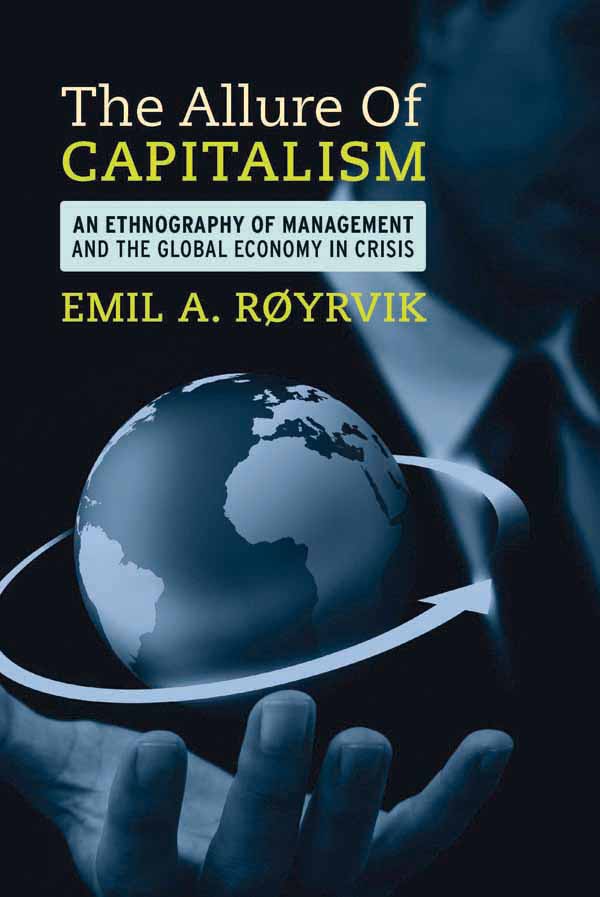
The Allure of Capitalism The “managerial revolution,†or the rise of management as a distinct and vital group in industrial society, might be identified as a major development of the modernization processes, similar to the scientific and industrial revolutions. Studying “transnational†or “global†corporate management at the post-millennium moment provides a suitable focal point from which to investigate globalized (post)modernity and capitalism especially, and as such this book offers an anthropology of global capitalism at its moment of crisis. This study provides ethnographically rich descriptions of managerial practices in a set of international corporate investment projects. Drawing also on historical and statistical data, it renders a comprehensive perspective on management, corporations, and capitalism in the late modern globalized economy. Cross-disciplinary in outlook, the book spans the fields of organization, business, and management, and asserts that now, in this period of financial crisis, is the time for anthropology to yet again engage with political economy. POLITICAL SCIENCE,Political Economy
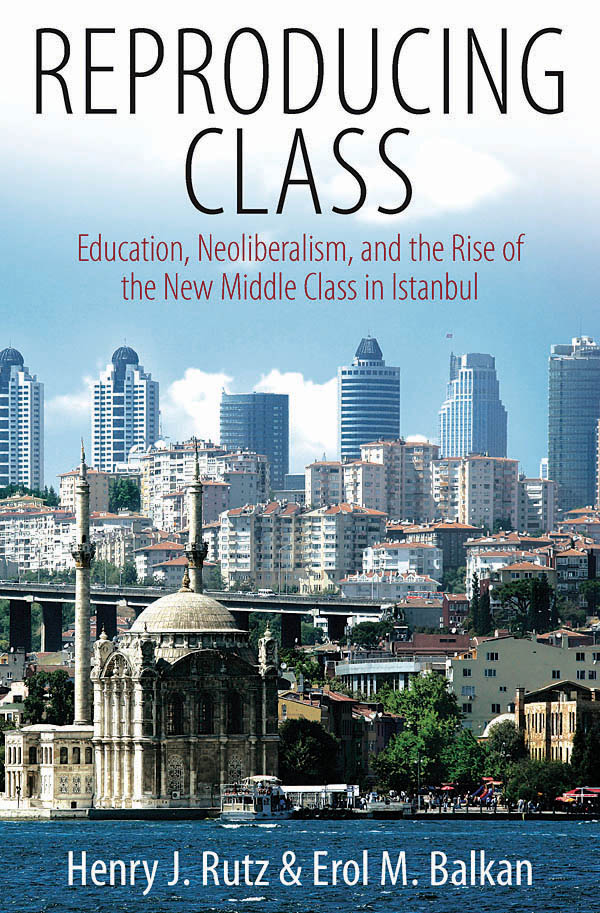
Reproducing Class Middle classes are by definition ambiguous, raising all sorts of paradoxical questions, perceived and real, about their power and place relative to those above and below them in a class-structured society. Focusing on families of the new middle class in Istanbul, the authors of this study address questions about the social construction of middle-class reality in the context of the rapid changes that have come about through recent economic growth in global markets and the global diffusion of information technology. After 1980, Turkey saw a structural transformation from state-owned and managed industry, banking, and media and communications to privatization and open markets. The idea of being middle class and the reality of middle-class practices became open for negotiation and interpretation. This study therefore offers a particularly interesting case study of an emergent global phenomenon known as the transnational middle class, characterized by their location of work in globalizing cities, development of transnational social networks, sumptuary consumption habits, and residences in gated communities. As the authors show, this new middle class associates quality education, followed by property and lifestyle issues, with the concept of a comfortable life. POLITICAL SCIENCE,Political Economy
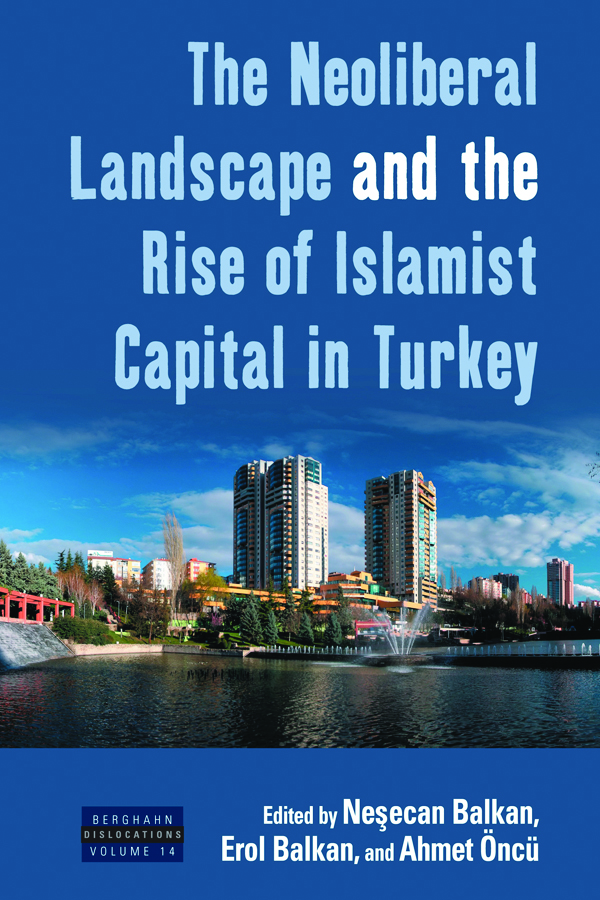
The Neoliberal Landscape and the Rise of Islamist Capital in Turkey Islamist capital accumulation has split the Turkish bourgeoisie and polarized Turkish society into secular and religious social groupings, giving rise to conflicts between the state and political Islam. By providing a long-term historical perspective on Turkey's economy and its relationship to Islamism, this volume explores how Islamism as a political ideology has been utilized by the conservative bourgeoisie in Turkey, and elsewhere, to establish hegemony over labor. The contributors analyze the relationship between neoliberalism and the political fortunes of the Islamist Justice and Development Party (AKP), and examine the similarities and differences amongst new factions in the secular and Islamic middle class that have benefited economically, socially, and culturally during the AKP's reign. The articles also investigate the impact of the Gülen Movement and the role of the media in shaping the contours of intra-class struggle within contemporary Turkish political and social life. POLITICAL SCIENCE,Political Economy
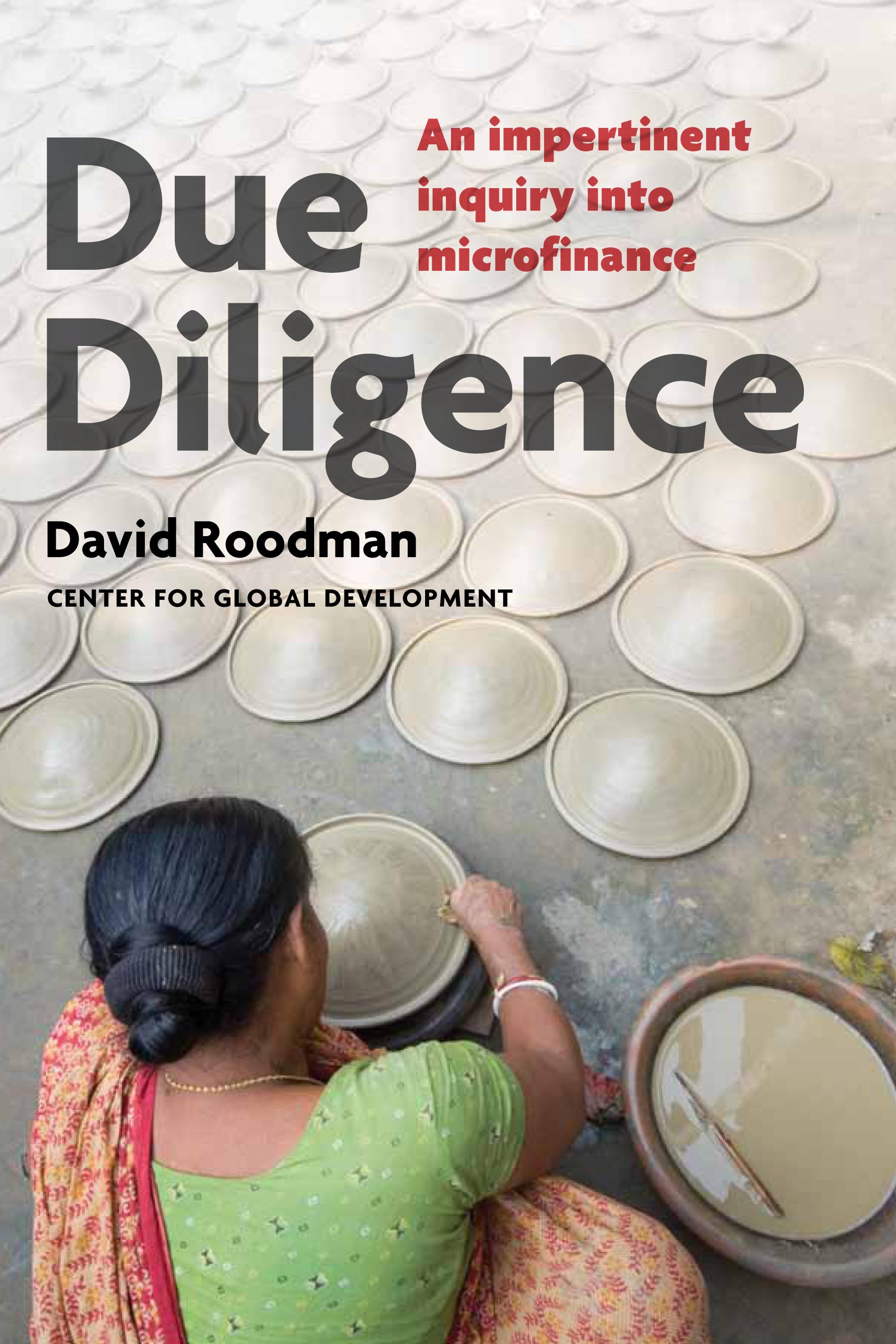
Due Diligence The idea that small loans can help poor families build businesses and exit poverty has blossomed into a global movement. The concept has captured the public imagination, drawn in billions of dollars, reached millions of customers, and garnered a Nobel Prize. Radical in its suggestion that the poor are creditworthy and conservative in its insistence on individual accountability, the idea has expanded beyond credit into savings, insurance, and money transfers, earning the name microfinance. But is it the boon so many think it is? Readers of David Roodman's openbook blog will immediately recognize his thorough, straightforward, and trenchant analysis. Due Diligence, written entirely in public with input from readers, probes the truth about microfinance to guide governments, foundations, investors, and private citizens who support financial services for poor people. In particular, it explains the need to deemphasize microcredit in favor of other financial services for the poor. POLITICAL SCIENCE,Political Economy
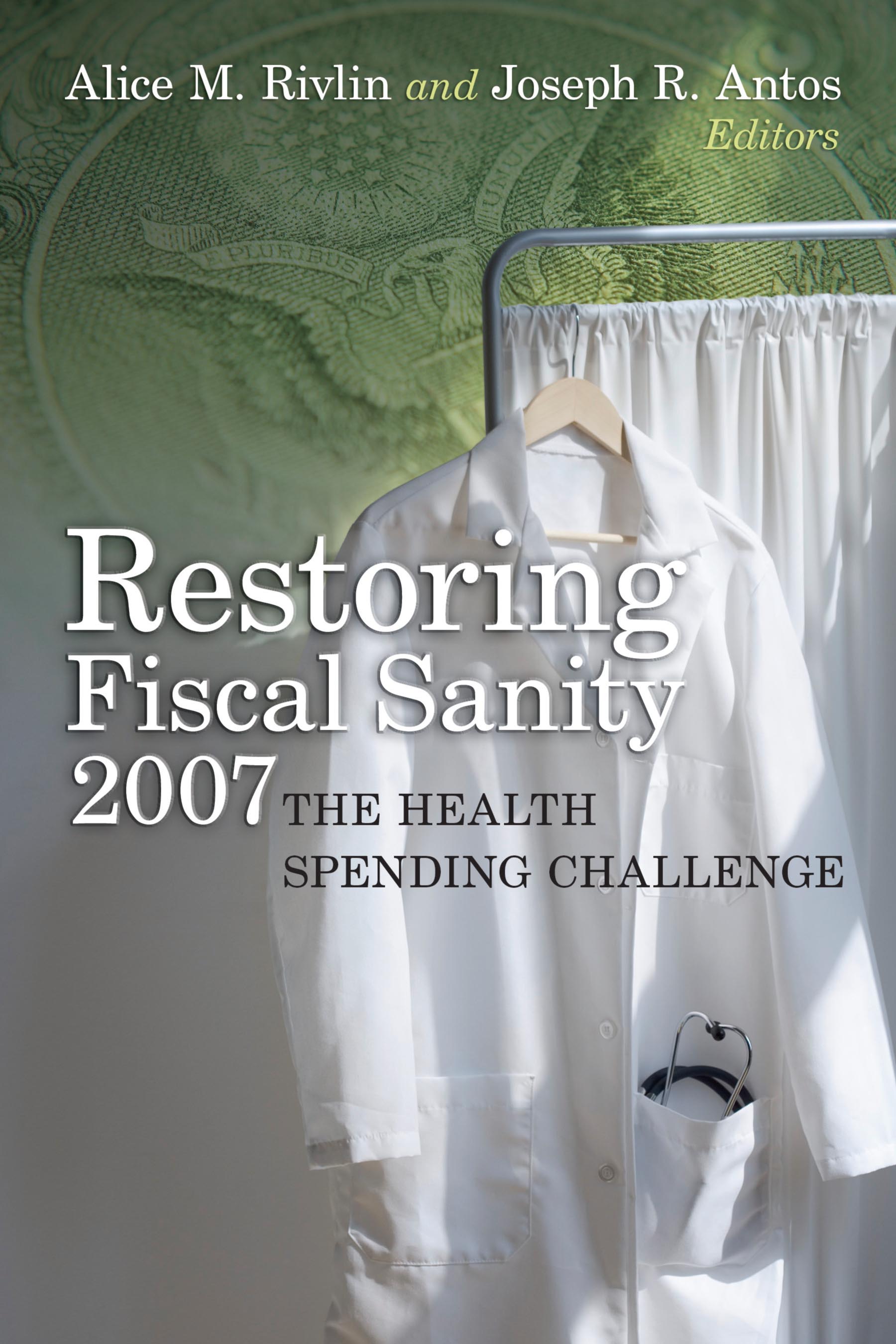
Restoring Fiscal Sanity 2007 Exceeding $2 trillion annually, health care spending in the United States is growing significantly faster than the national economy. If left unchecked, this health spending crisis will threaten Americans' ability to pay for other essential services. Driven primarily by the cost of benefits promised to seniors under Medicare and Medicaid, federal health expenditures will force lawmakers to make stark policy decisions. In this third volume of Restoring Fiscal Sanity, policy experts suggest ways to slow the growth of federal spending on health care. Unless federal health spending can be brought under control, Americans will face substantially higher taxes, sharp reductions in other government programs, and cuts in benefits to the elderly. Families, businesses, and communities will be forced to make agonizing choices between health care and other needs. Focusing on policies that do not shift costs to the states or the private sector, the authors of Restoring Fiscal Sanity 2007 suggest reforms in federal programs that have the potential to reduce the growth of spending for the entire health system, increase the efficiency and effectiveness of the care provided, and enhance health outcomes. Drawing on years of government and public policy experience, they stress the need for innovative approaches and cooperation between the private and public sectors. POLITICAL SCIENCE,Political Economy
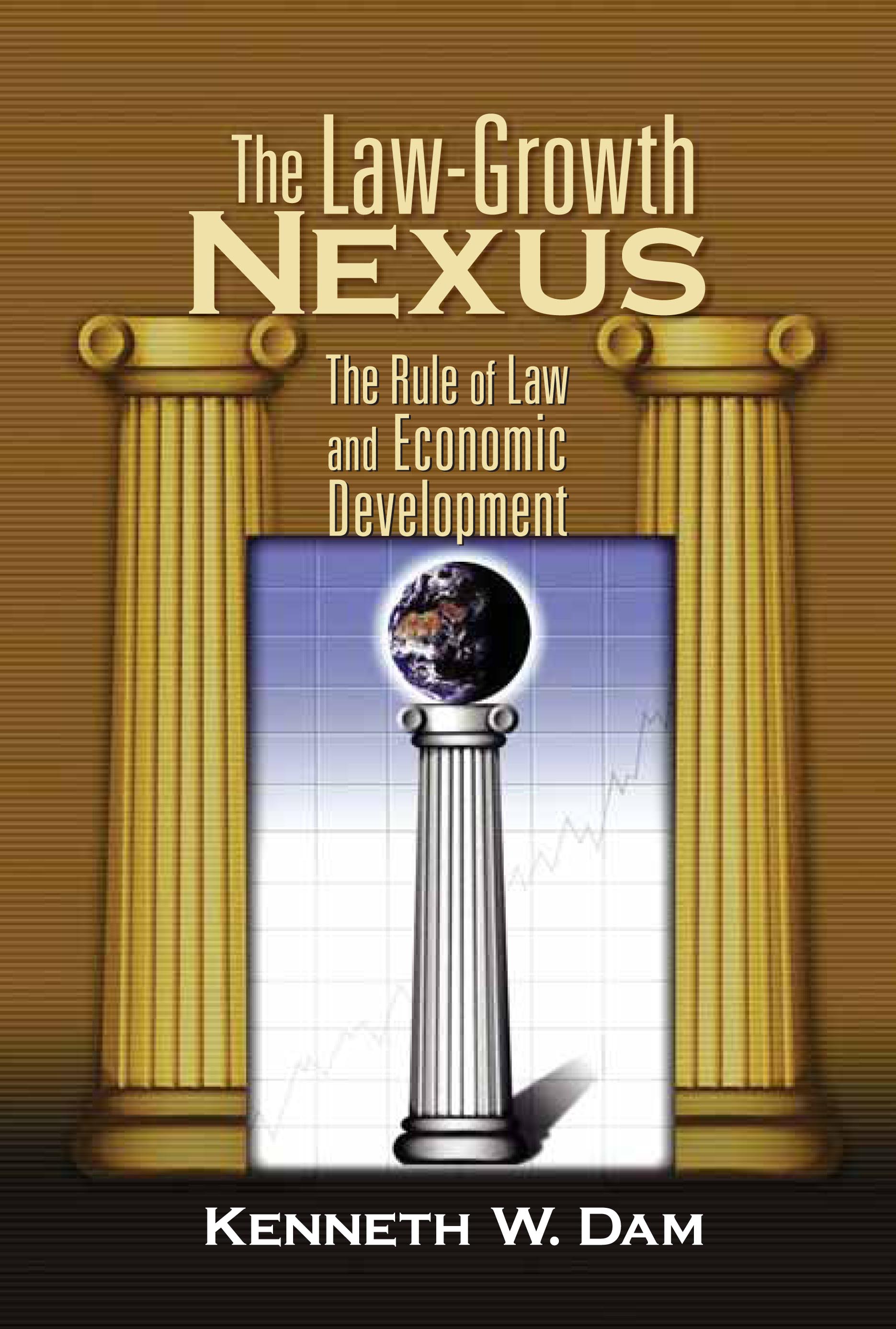
The Law-Growth Nexus An increasingly popular view holds that institutions--in particular, the rule of law--are the keys to unlocking the developing world's full growth potential. But what exactly does this mean? Which legal institutions matter and why? How can policymakers use this knowledge to promote growth? In The Law-Growth Nexus, Kenneth Dam brings five decades of experience as a legal scholar and policymaker to bear upon these questions. After reviewing the burgeoning literature on legal institutions and economic development, Dam unpacks the "rule of law" concept. Successive chapters analyze enforcement, contracts, and property rightsthe three concepts that collectively define rule of lawand examine their roles in the real estate and financial sectors. Dam uses an extended analysis of China to assess the importance of the rule of law. This case study illustrates several of the book's central themes, including the difficulty of building a strong, independent judiciary and firstclass financial sector. The stark fact is that many parts of what we call the developing world have stopped developing, while other regions have seen a slowdown in once-promising growth. Could new or better legal institutions help jumpstart these economies? In exploring this question, Th e Law-Growth Nexus goes beyond regression results to examine the underlying mechanisms through which the law, the judiciary, and the legal profession influence the economy. The result is essential reading for analysts and policymakers facing the challenges of legal and economic reform. POLITICAL SCIENCE,Political Economy

When Small States Make Big Leaps Darius Ornston explains how several of Europe's technological laggards, in particular Denmark, Finland, and Ireland, managed to assume leading positions in new, high-tech industries: biotechnology, software, telecommunications equipment. POLITICAL SCIENCE,Political Economy

The Power of Inaction Cornelia Woll details the varying relationships between financial institutions and national governments by comparing national bank rescue schemes in the United States and Europe. POLITICAL SCIENCE,Political Economy

Chinese Economic Statecraft In Chinese Economic Statecraft, William J. Norris introduces an innovative theory that pinpoints how states employ economic tools of national power to pursue their strategic objectives. Norris shows what Chinese economic statecraft is, how it works, and why it is more or less effective. POLITICAL SCIENCE,Political Economy
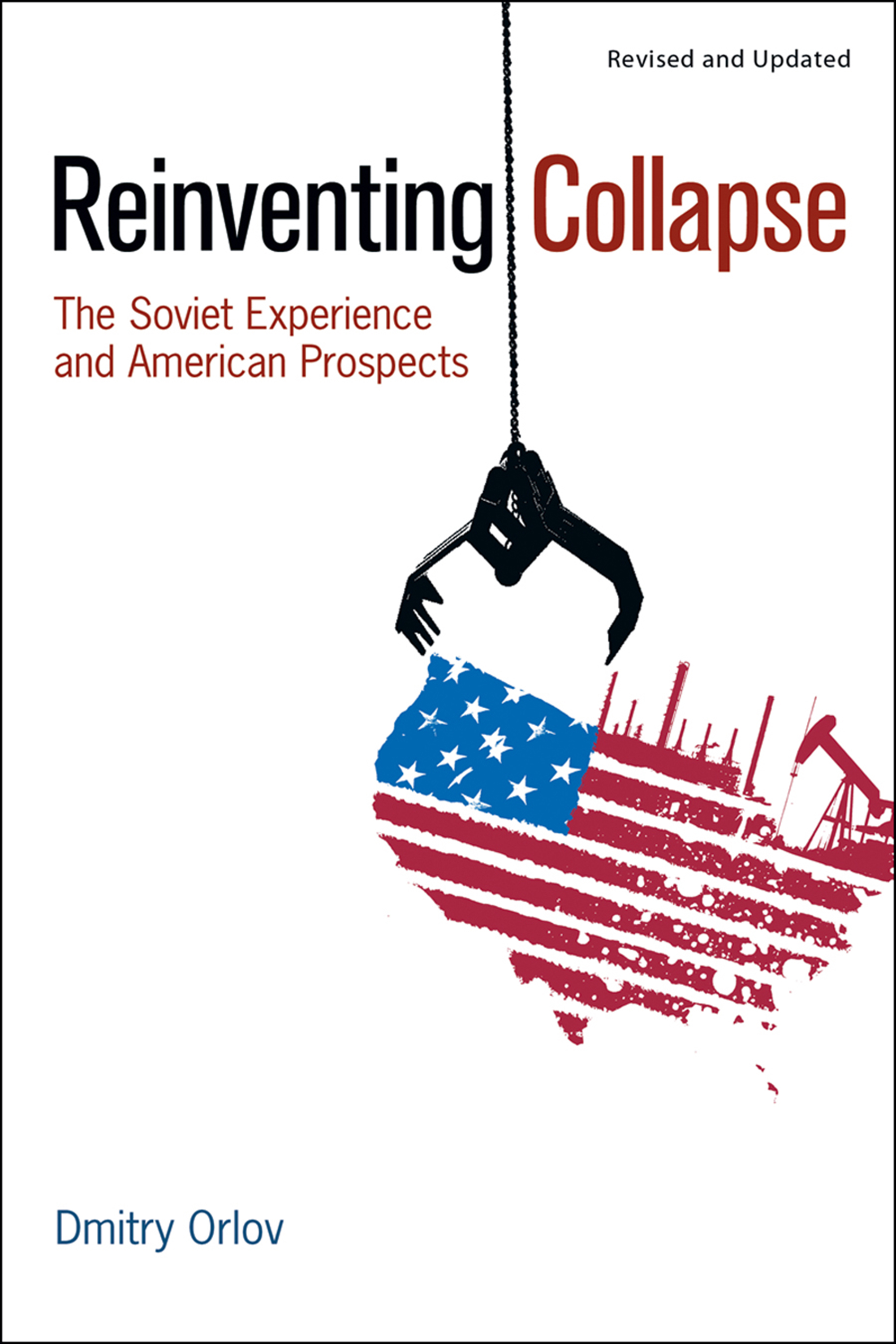
Reinventing Collapse This new edition of Reinventing Collapse is an update on the growing similarities and differences between the collapse of the Soviet Union and the current unraveling of the United States. Dmitry Orlov shares his personal experiences in post-industrial living and argues that US collapse is survivable given the right attitude and preparation. POLITICAL SCIENCE,Political Economy
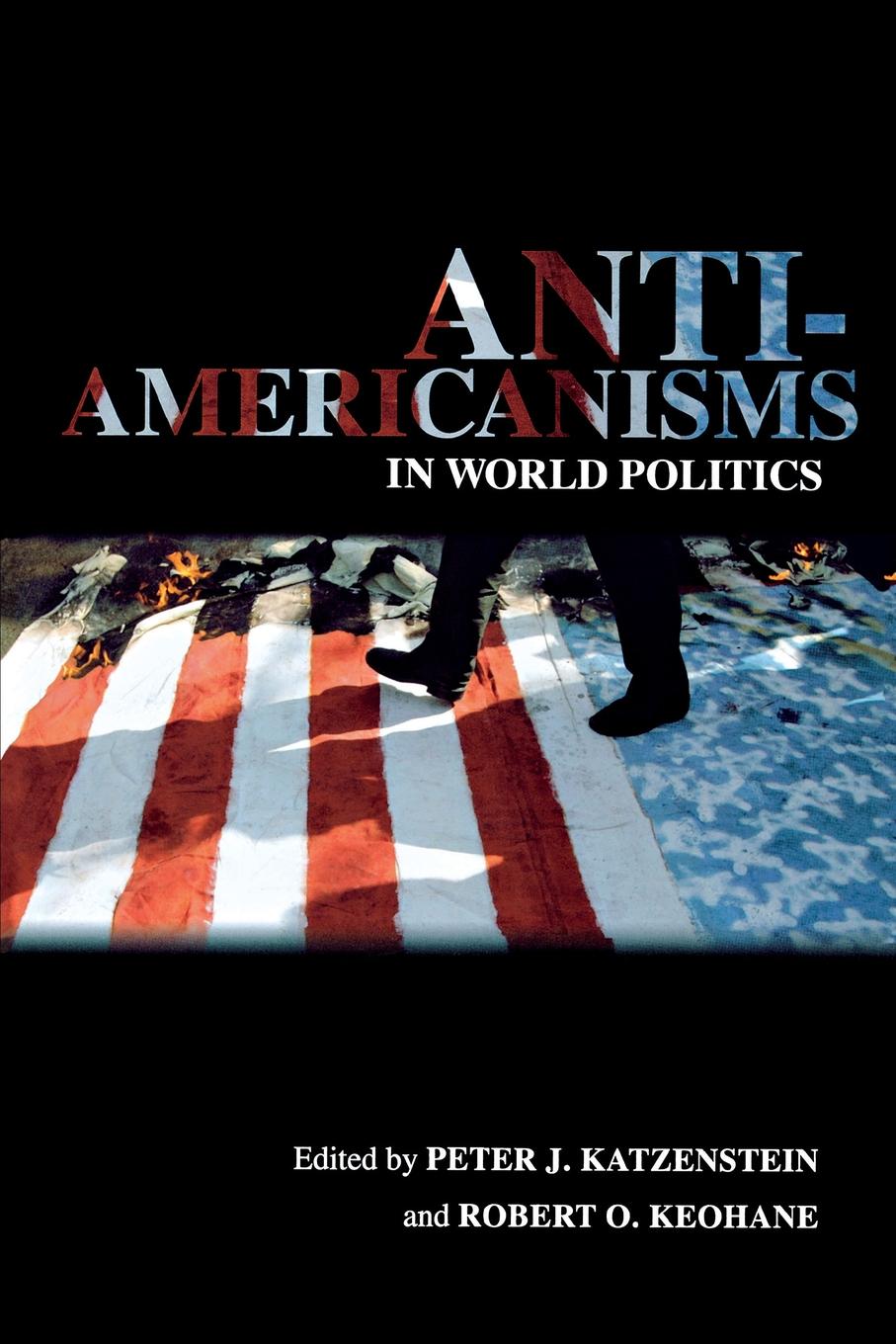
Anti-Americanisms in World Politics A distinguished group of experts, including historians, polling data analysts, political scientists, anthropologists, and sociologists, to explore global anti-Americanism in depth, using both qualitative and quantitative methods. POLITICAL SCIENCE,Political Economy

Ending Empire At the dawn of the twentieth century, imperial powers controlled most of the globe. Within a few decades after World War II, many of the great empires had dissolved, and more recently, multinational polities have similarly disbanded. This process of... POLITICAL SCIENCE,Political Economy
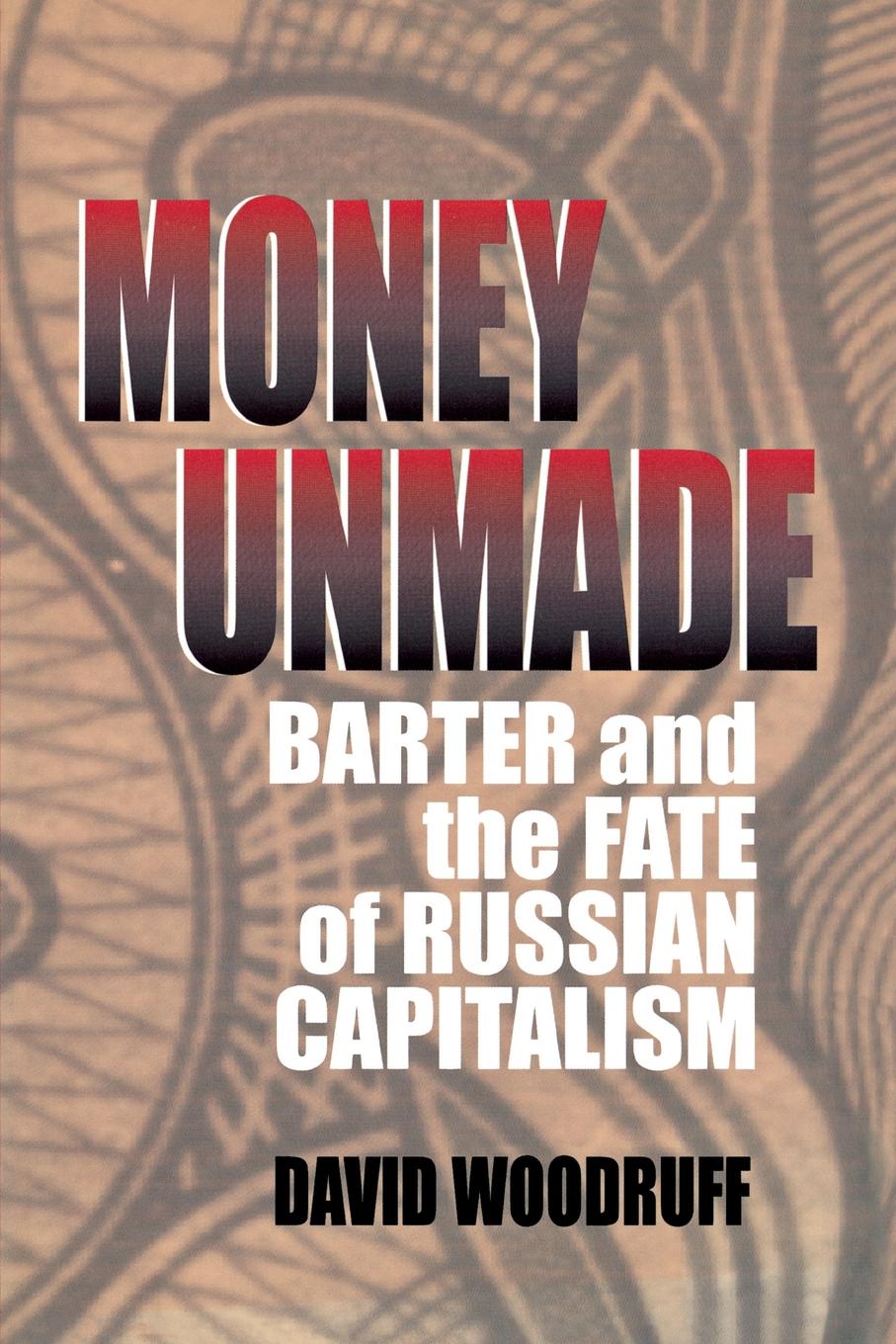
Money Unmade Since the collapse of the Soviet Union, Russians have seen the ruble steadily lose ground to alternative means of payment such as barter and privately issued quasi-monies. Industry now collects as much as 70 percent of its receipts in nonmonetary... POLITICAL SCIENCE,Political Economy
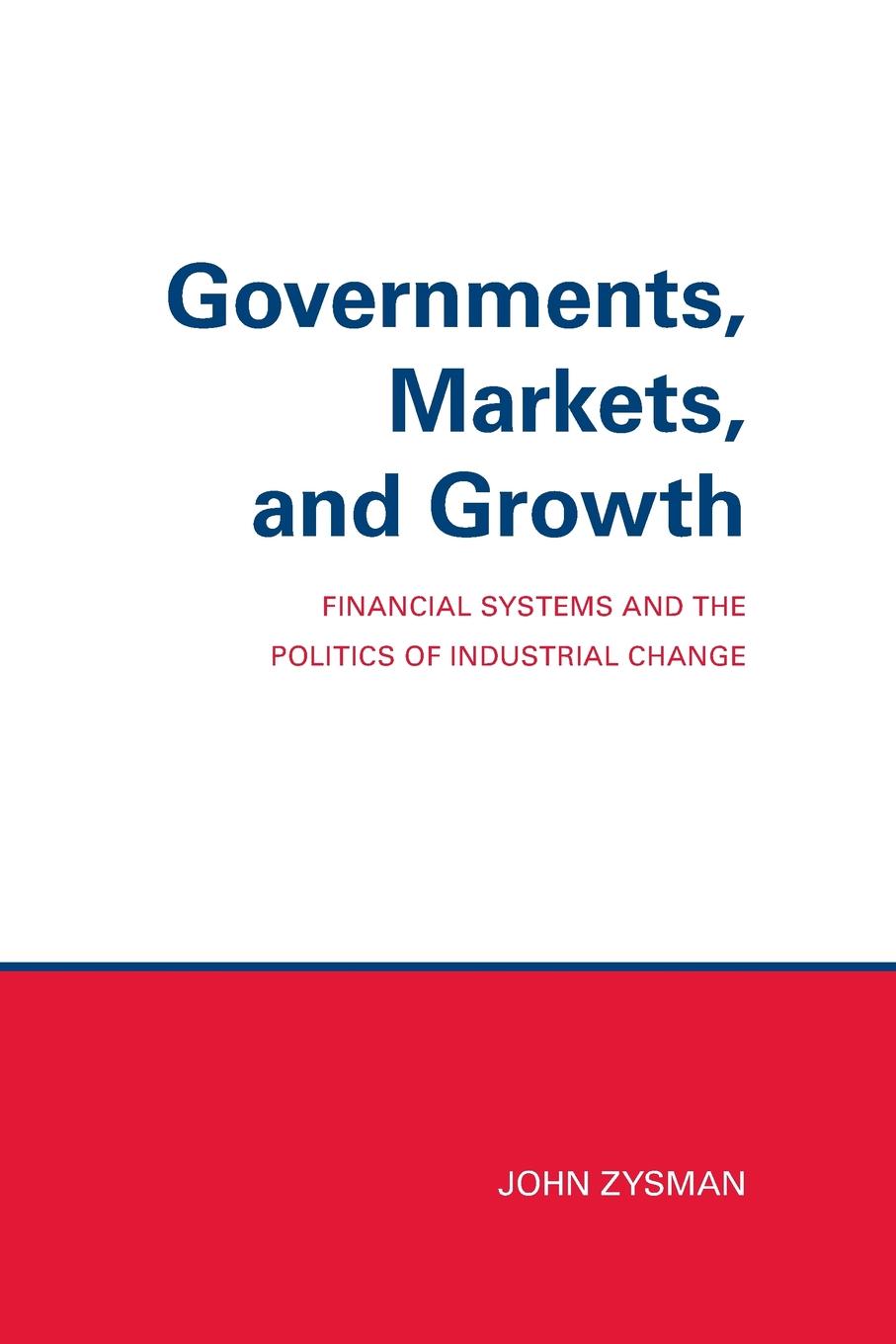
Governments, Markets, and Growth Zysman demonstrates that there is a direct relationship between a nation's financial system and its government's ability to restart the growth engine. POLITICAL SCIENCE,Political Economy
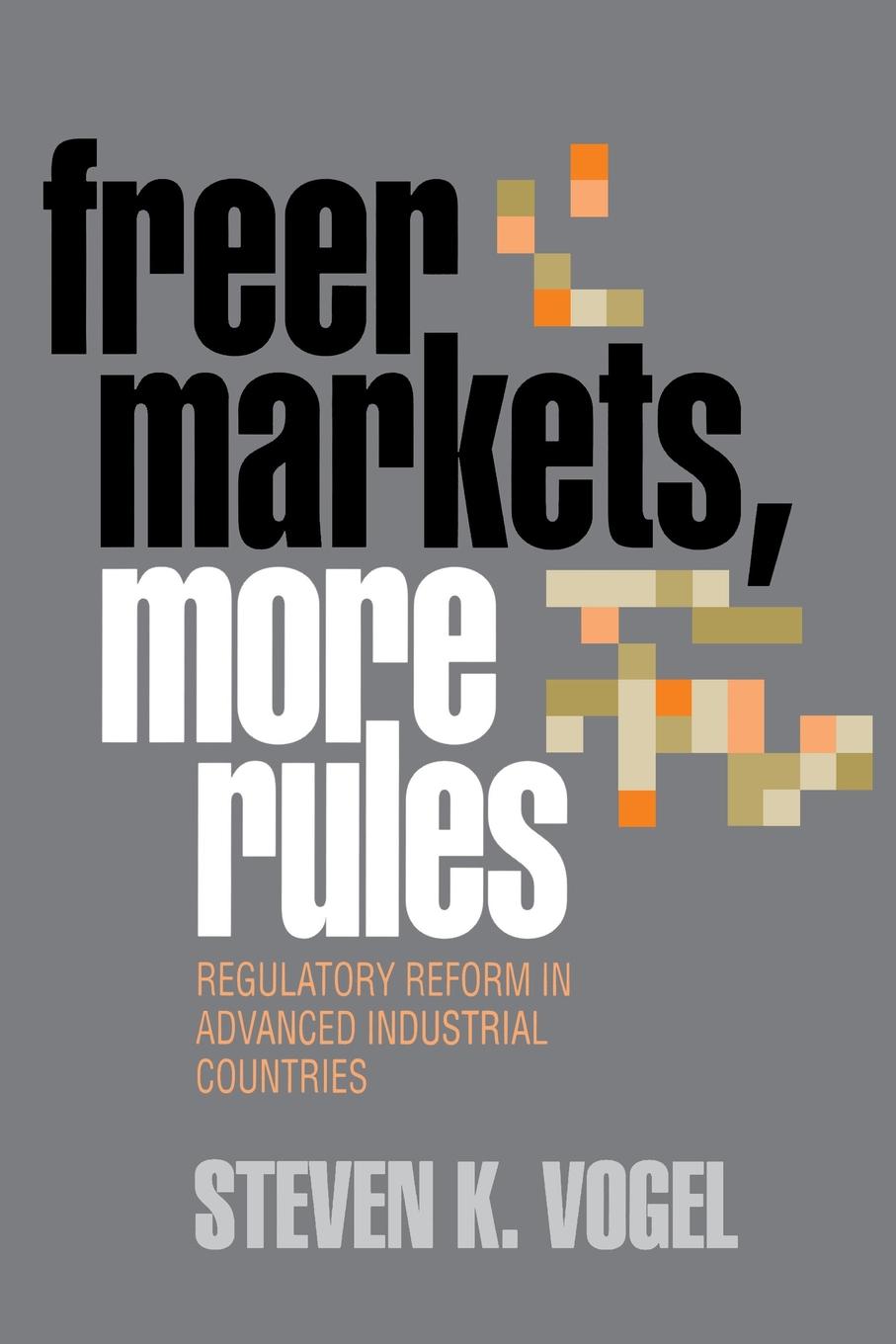
Freer Markets, More Rules Over the past fifteen years, the United States, Western Europe, and Japan have transformed the relationship between governments and corporations. The changes are complex and the terms used to describe them often obscure the reality. In Freer Markets... POLITICAL SCIENCE,Political Economy

Are Markets Moral? Are Markets Moral? explores the vexed relationship between moral values and free market economics. Essays consider whether the principles and practical workings of the capitalist system erode moral character and prevent the just distribution of goods or whether, on the contrary, they promote good character and just outcomes. POLITICAL SCIENCE,Political Economy

The Killing of Uncle Sam Pride, greed, and power have driven men to do the unthinkable–including selling out their nations and unsuspected citizens to the most corrupt and destructive “invisible†global leaders on Earth. But how did this happen on American soil? How did the downfall begin and who were the predators that the “land of the free and home of the brave†fell victim to? And is all hope lost? This book captures details of the last 200 years of American history that mainstream media does not want you to know. It dissects the “legalized†system of the private central banks that has gone unchecked, and delivers gut-wrenching truths about the real domestic and foreign enemies of the United States. With over 1000 footnotes and quotes from former presidents, prime ministers, and state officials, it will equip you with the facts that the elites have covered up for centuries and empower you to stand up for the truth. POLITICAL SCIENCE,Political Economy
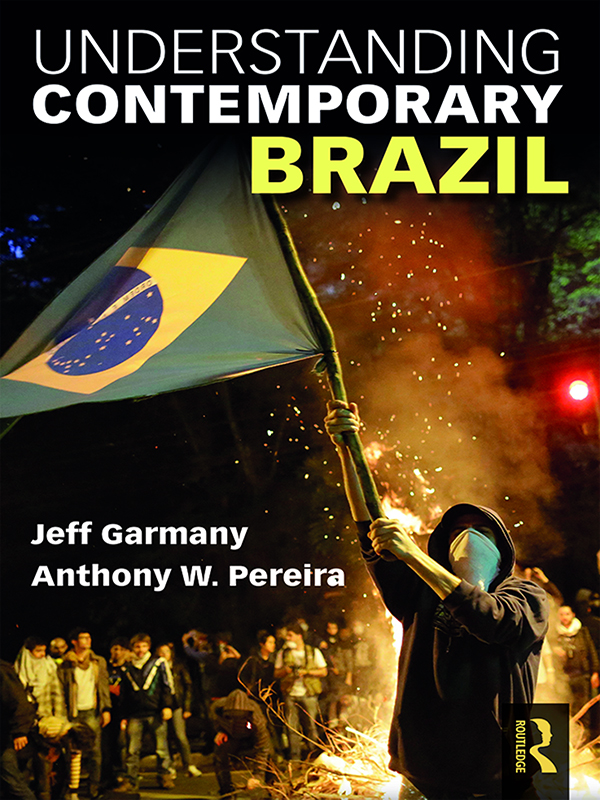
Understanding Contemporary Brazil Brazil has famously been called a country of contradictions. It is a place where narratives of "racial democracy" exist in the face of stark inequalities, and where the natural environment is celebrated as a point of national pride, but at the same time is exploited at alarming rates. To people on the outside looking in, these contradictions seem hard to explain. Understanding Contemporary Brazil tackles these problems head-on, providing the perfect critical introduction to Brazil's ongoing social, political, economic, and cultural complexities. Key topics include: • National identity and political structure. • Economic development, environmental contexts, and social policy. • Urban issues and public security. • Debates over culture, race, gender, and spirituality. • Social inequality, protest, and social movements. • Foreign diplomacy and international engagement. By considering more broadly the historical, political economic, and socio-cultural roots of Brazil’s internal dynamics, this interdisciplinary book equips readers with the contextual understanding and critical insight necessary to explore this fascinating country. Written by renowned authors at one of the world's most important centers for the study of Brazil, Understanding Contemporary Brazil is ideal for university students and researchers, yet also accessible to any reader looking to learn more about one of the world's largest and most significant countries. POLITICAL SCIENCE,Political Economy
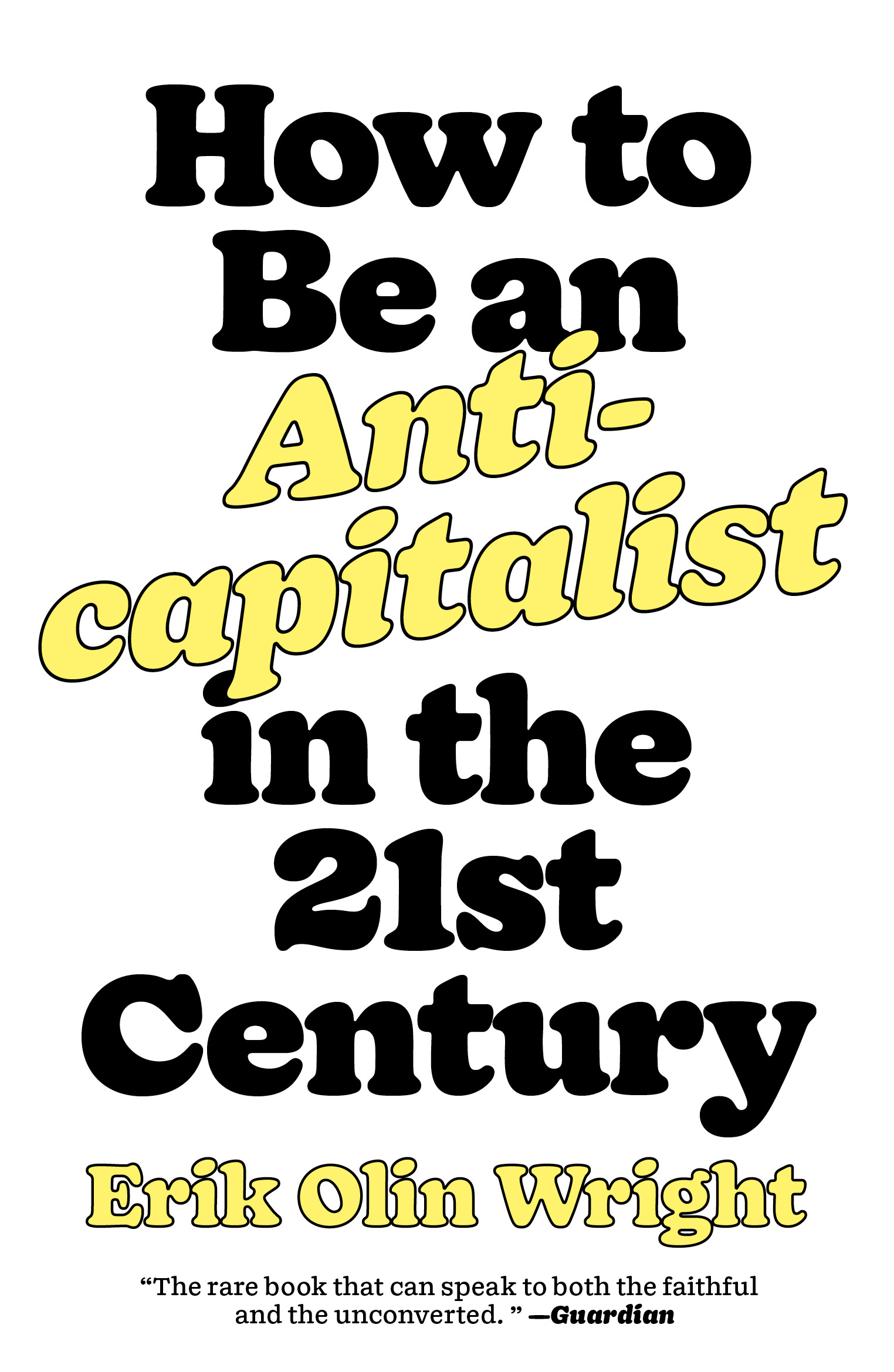
How to Be an Anticapitalist in the Twenty-First Century What is wrong with capitalism, and how can we change it? Capitalism has transformed the world and increased our productivity, but at the cost of enormous human suffering. Our shared values—equality and fairness, democracy and freedom, community and solidarity—can provide both the basis for a critique of capitalism and help to guide us toward a socialist and democratic society. Erik Olin Wright has distilled decades of work into this concise and tightly argued manifesto: analyzing the varieties of anticapitalism, assessing different strategic approaches, and laying the foundations for a society dedicated to human flourishing. How to Be an Anticapitalist in the Twenty-First Century is an urgent and powerful argument for socialism, and an unparalleled guide to help us get there. Another world is possible. Included is an afterword by the author’s close friend and collaborator Michael Burawoy. POLITICAL SCIENCE,Political Economy
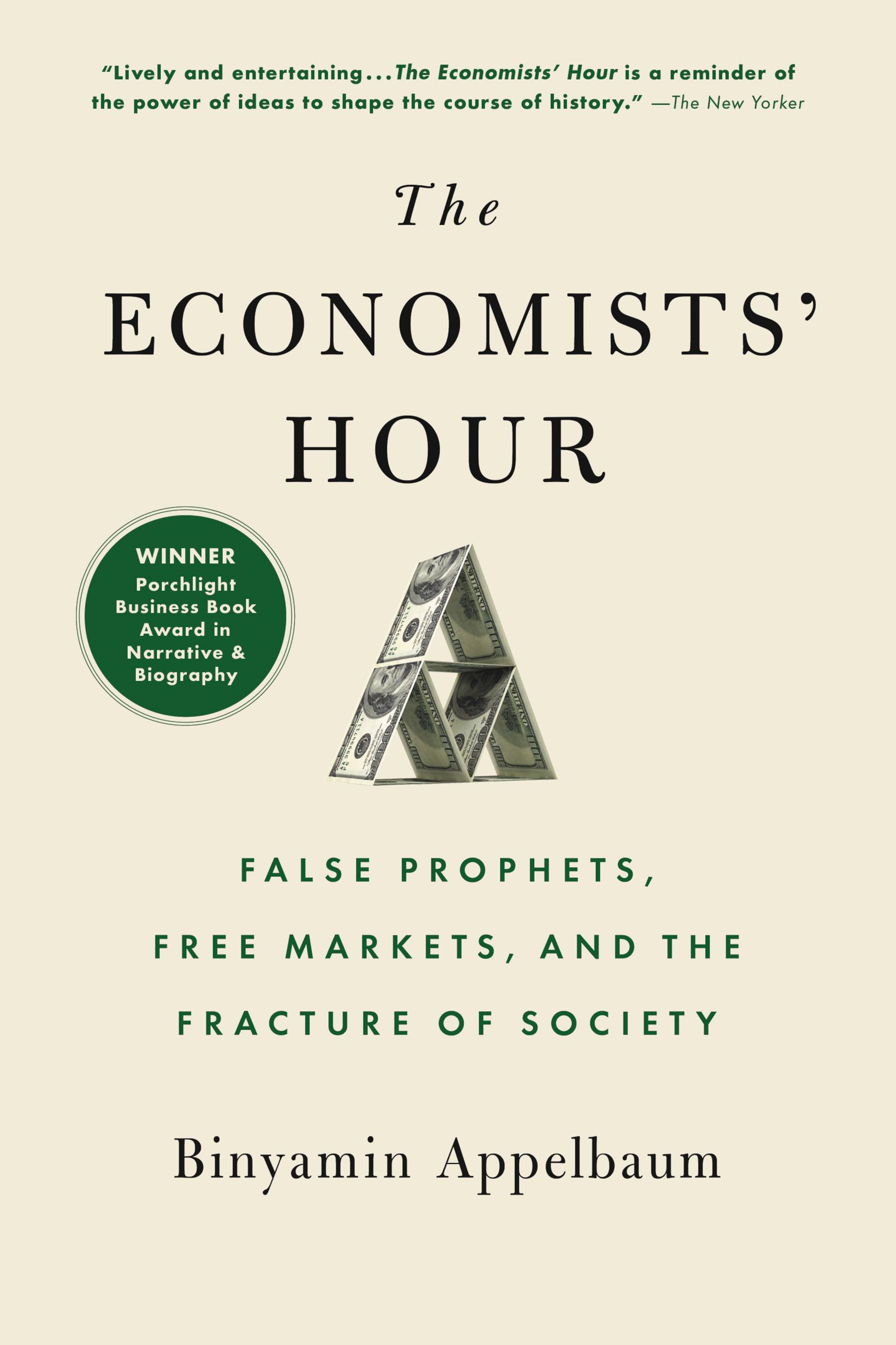
The Economists' Hour In this "lively and entertaining" history of ideas (Liaquat Ahamed, The New Yorker), New York Times editorial writer Binyamin Appelbaum tells the story of the people who sparked four decades of economic revolution. Before the 1960s, American politicians had never paid much attention to economists. But as the post-World War II boom began to sputter, economists gained influence and power. In The Economists' Hour, Binyamin Appelbaum traces the rise of the economists, first in the United States and then around the globe, as their ideas reshaped the modern world, curbing government, unleashing corporations and hastening globalization. Some leading figures are relatively well-known, such as Milton Friedman, the elfin libertarian who had a greater influence on American life than any other economist of his generation, and Arthur Laffer, who sketched a curve on a cocktail napkin that helped to make tax cuts a staple of conservative economic policy. Others stayed out of the limelight, but left a lasting impact on modern life: Walter Oi, a blind economist who dictated to his wife and assistants some of the calculations that persuaded President Nixon to end military conscription; Alfred Kahn, who deregulated air travel and rejoiced in the crowded cabins on commercial flights as the proof of his success; and Thomas Schelling, who put a dollar value on human life. Their fundamental belief? That government should stop trying to manage the economy. Their guiding principle? That markets would deliver steady growth, and ensure that all Americans shared in the benefits. But the Economists' Hour failed to deliver on its promise of broad prosperity. And the single-minded embrace of markets has come at the expense of economic equality, the health of liberal democracy, and future generations. Timely, engaging and expertly researched, The Economists' Hour is a reckoning -- and a call for people to rewrite the rules of the market. A Wall Street Journal Business Bestseller Winner of the Porchlight Business Book Award in Narrative & Biography POLITICAL SCIENCE,Political Economy
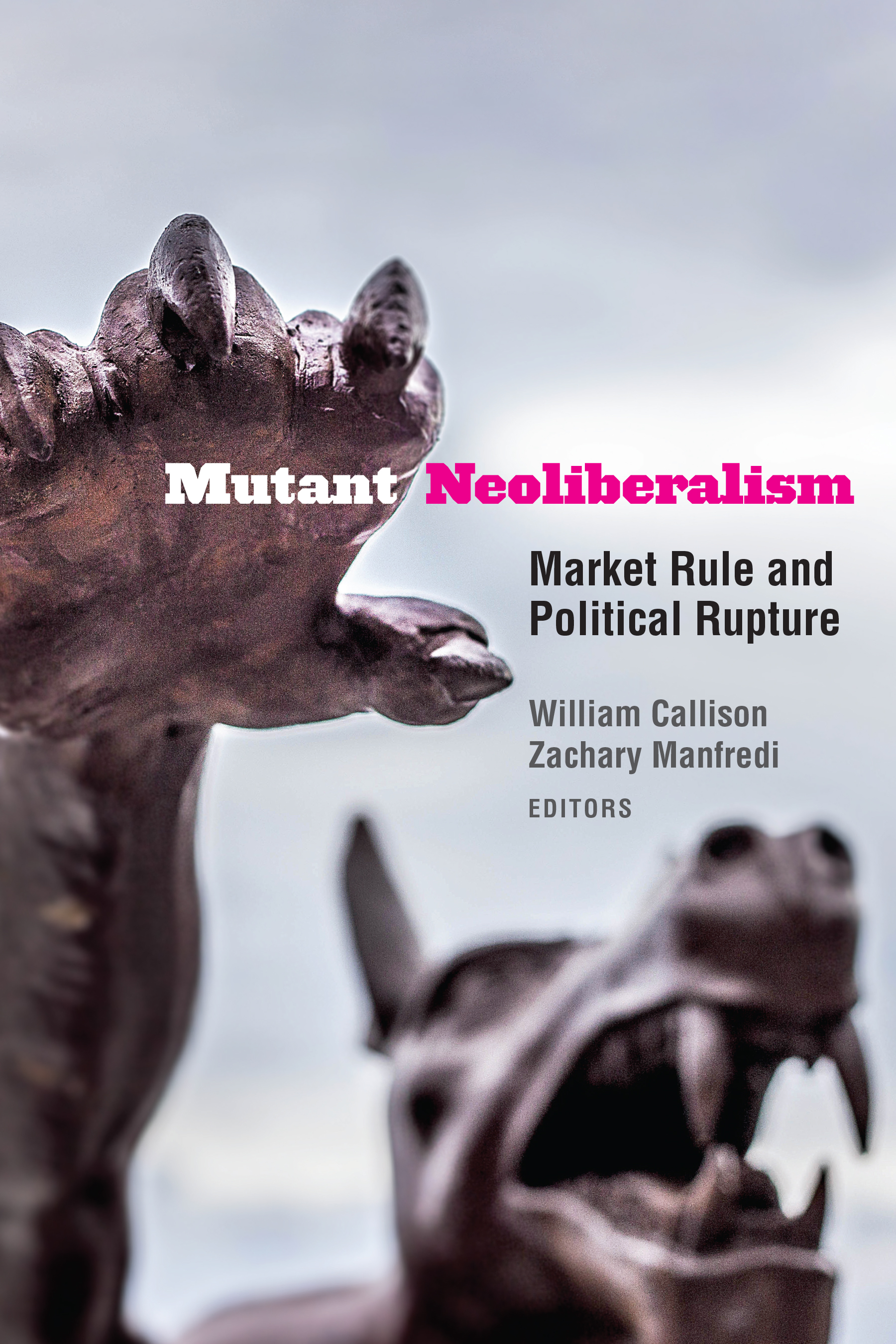
Mutant Neoliberalism This interdisciplinary collection, featuring some of today’s most prominent political theorists, sociologists, philosophers, and historians, challenges narratives of neoliberalism’s demise. The book queries whether contemporary political ruptures—including the rise of far-right forces—will challenge, support, or extend the reach of market rule around the globe. POLITICAL SCIENCE,Political Economy

The Regional World Order This book compares existing approaches to regionalism and transregionalism and discusses its global impact on world politics and economy. It argues that for the changing world order, the development of transregionalism would have benign implications on the global level. POLITICAL SCIENCE,Political Economy
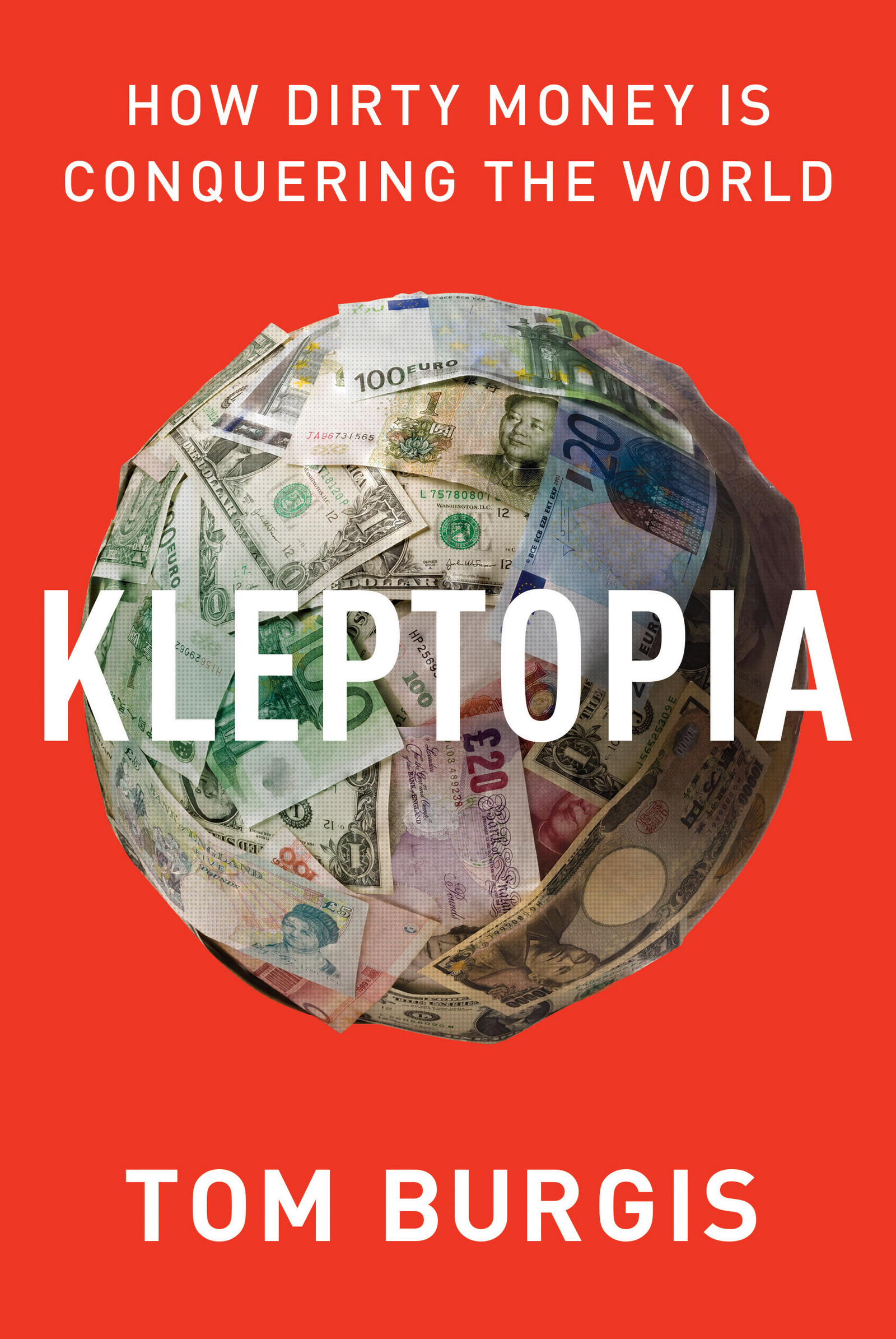
Kleptopia “A must-read for anyone wanting to better understand what has already happened here in America and what lies ahead if Trump is reelected in November…. A magisterial account of the money and violence behind the world’s most powerful dictatorships.†–Washington Post In this shocking, meticulously reported work of narrative nonfiction, an award-winning investigative journalist exposes “capitalism’s monsterâ€â€”global kleptocracy—and reveals how it is corrupting the world around us. They are everywhere, the thieves and their people. Masters of secrecy. Until now we have detected their presence only by what they leave behind. A body in a burned-out Audi. Workers riddled with bullets in the Kazakh Desert. A rigged election in Zimbabwe. A British banker silenced and humiliated for trying to expose the truth about the City of London. They have amassed more money than most countries. But what they are really stealing is power. In this real-life thriller packed with jaw-dropping revelations, award-winning investigative journalist Tom Burgis weaves together four stories that reveal a terrifying global web of corruption: the troublemaker from Basingstoke who stumbles on the secrets of a Swiss bank, the ex-Soviet billionaire constructing a private empire, the righteous Canadian lawyer with a mysterious client, and the Brooklyn crook protected by the CIA. Glimpses of this shadowy world have emerged over the years. In Kleptopia, Burgis connects the dots. He follows the dirty money that is flooding the global economy, emboldening dictators, and poisoning democracies. From the Kremlin to Beijing, Harare to Riyadh, Paris to the White House, the trail shows something even more sinister: the thieves are uniting. And the human cost will be great. POLITICAL SCIENCE,Political Economy
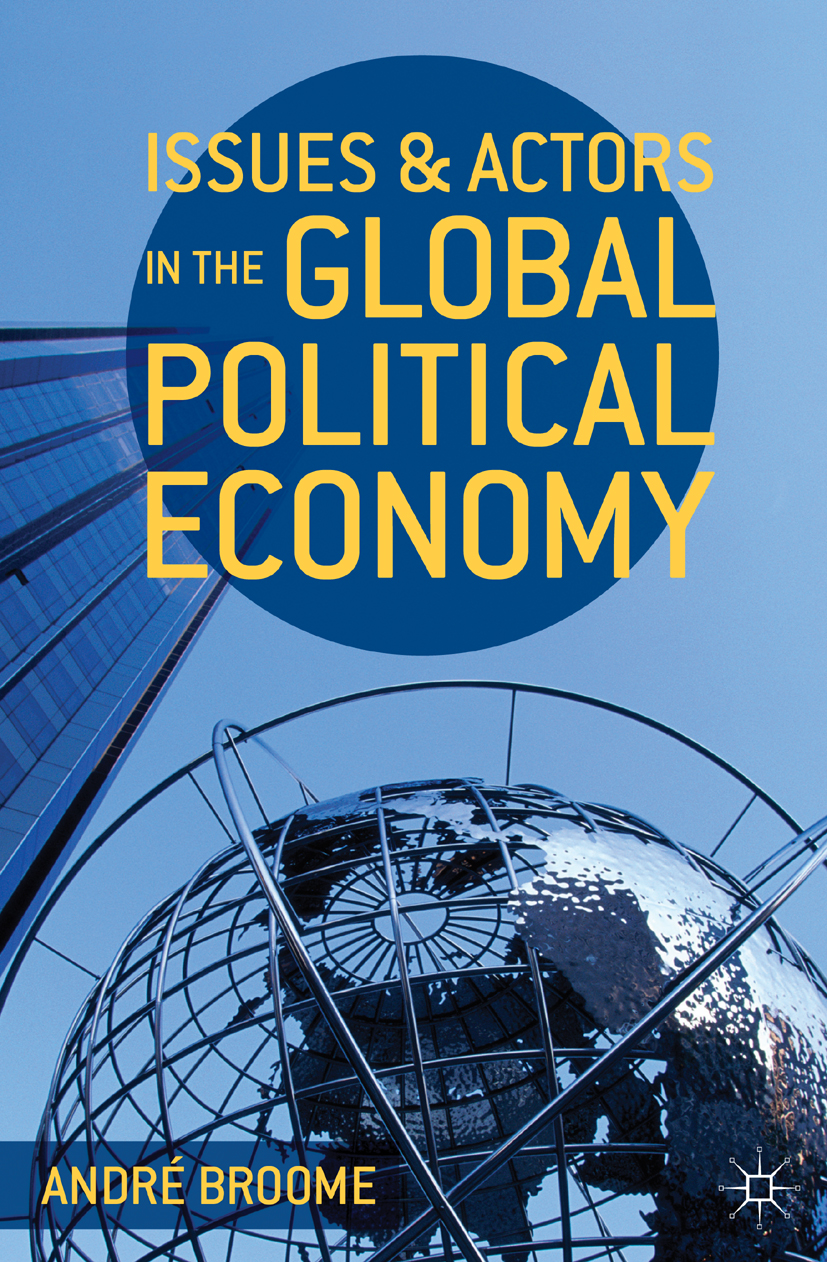
Issues and Actors in the Global Political Economy A major new text on contemporary global political economy that focuses centrally on key issues and actors. Concise and accessibly written, it provides an ideal introduction to the contemporary dynamics and processes of change in the global political economy. POLITICAL SCIENCE,Political Economy

Commercial Society The authors discuss the connections between the ethical, economic, and entrepreneurial dimensions of a life well-lived. POLITICAL SCIENCE,Political Economy
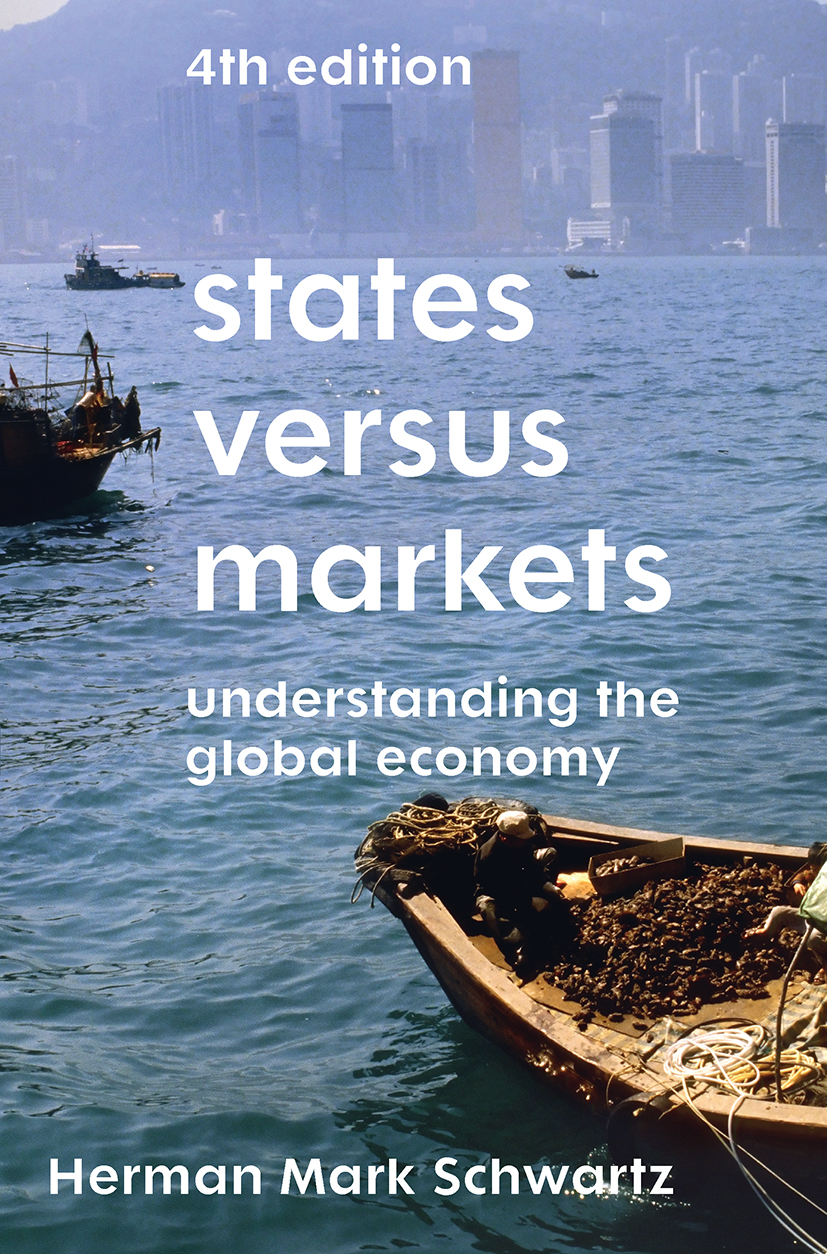
States Versus Markets States Versus Markets shows that globalization is not a novel phenomenon but a recurrent process whereby markets have, since the sixteenth century, periodically redistributed economic activity. This revised and updated new edition takes account of the new rise of Asia and the global financial crisis originating in the US housing finance system. POLITICAL SCIENCE,Political Economy
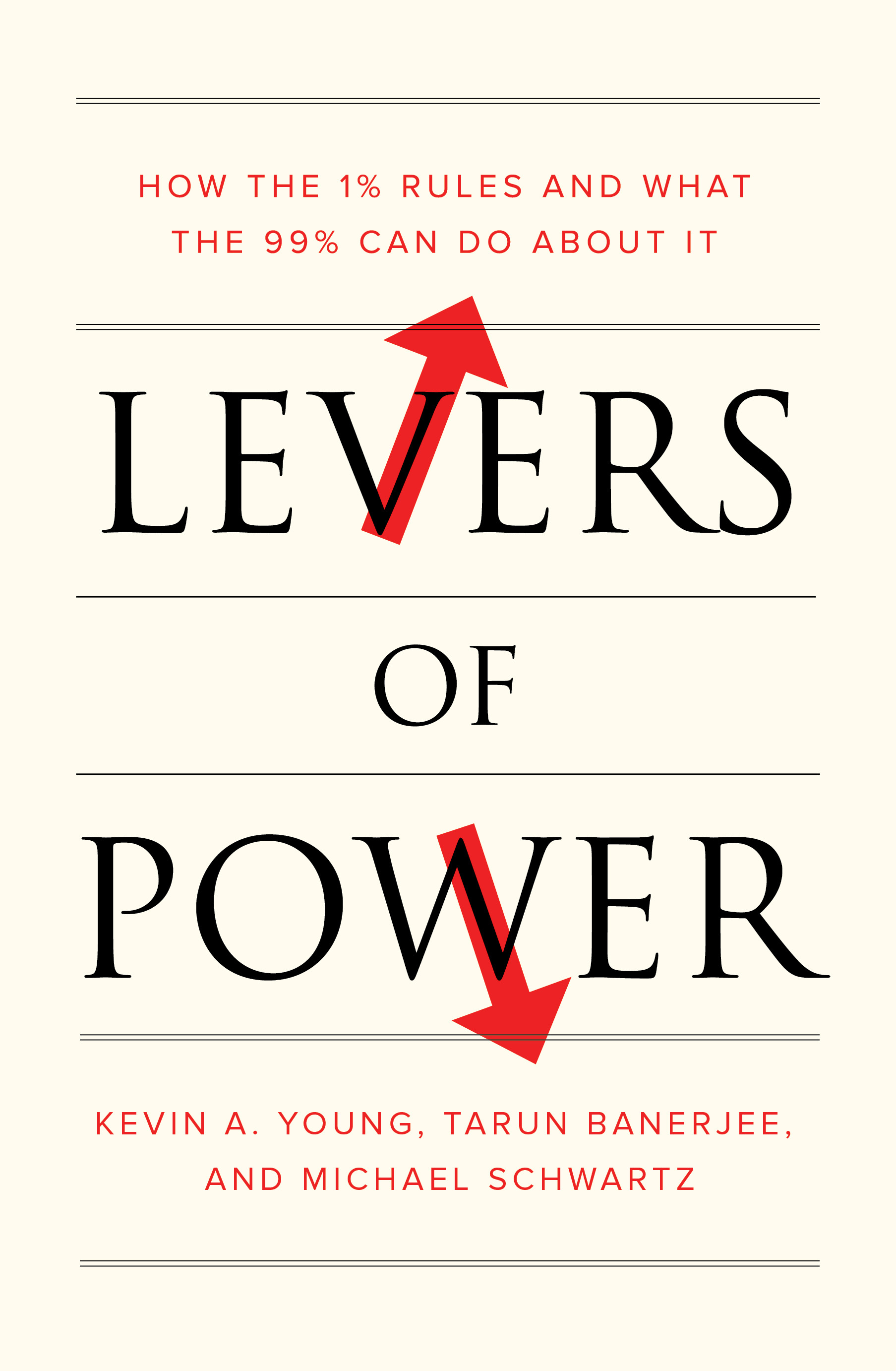
Levers of Power Understanding the power of the corporations and how to take the struggle directly to them It's no secret that "the 1%" - the business elite that commands the largest corporations and the connected network of public and private institutions- exercise enormous control over U.S. government. While this control is usually attributed to campaign donations and lobbying, Levers of Power argues that corporate power derives from control over the economic resources on which daily life depends. Government officials must constantly strive to keep capitalists happy, lest they go on "capital strike" - that is, refuse to invest in particular industries or locations, or move their holdings to other countries - and therefore impose material hardship on specific groups or the economy as a whole. For this reason, even politicians who are not dependent on corporations for their electoral success must fend off the interruption of corporate investment. Levers of Power documents the pervasive power of corporations and other institutions with decision-making control over large pools of capital, particularly the Pentagon. It also shows that the most successful reform movements in recent U.S. history - for workers' rights, for civil rights, and against imperialist wars - succeeded by directly targeting the corporations and other institutional adversaries that initiated and benefitted from oppressive policies. Though most of today's social movements focus on elections and politicians, movements of the "99%" are most effective when they inflict direct costs on corporations and their allied institutions. This strategy is also more conducive to building a revolutionary mass movement that can replace current institutions with democratic alternatives. POLITICAL SCIENCE,Political Economy
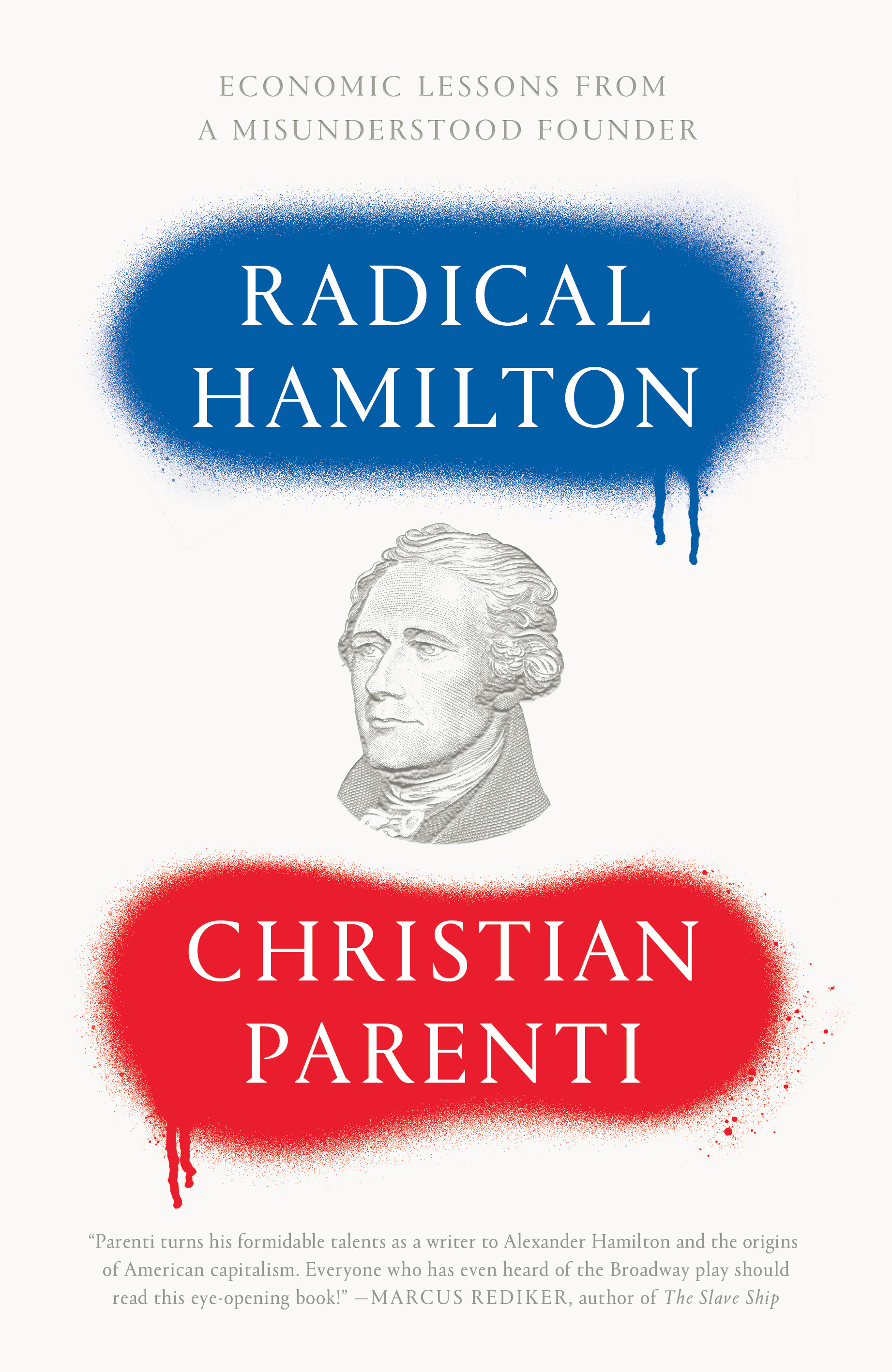
Radical Hamilton A dramatic re-evaluation of the founding of the United States and the history of capitalism. In retelling the story of the radical Alexander Hamilton, Parenti rewrites the history early America and global economic history writ large. For much of the twentieth century, Hamilton-sometimes seen as the bad boy of the founding fathers or portrayed as the patron saint of bankers-was out of fashion. In contrast his rival Thomas Jefferson, the patrician democrat and slave owner who feared government overreach, was claimed by all. But more recently, Hamilton has become a subject of serious interest again. He was a contradictory mix: a tough soldier, austere workaholic, exacting bureaucrat, yet also a sexual libertine, and a glory-obsessed romantic with suicidal tendencies. As Parenti argues, we have yet to fully appreciate Hamilton as the primary architect of American capitalism and the developmental state. In exploring his life and work, Parenti rediscovers this gadfly as a path breaking political thinker and institution builder. In this vivid historical portrait, Hamilton emerges as a singularly important historical figure: a thinker and politico who laid the foundation for America's ascent to global supremacy-for better or worse. POLITICAL SCIENCE,Political Economy
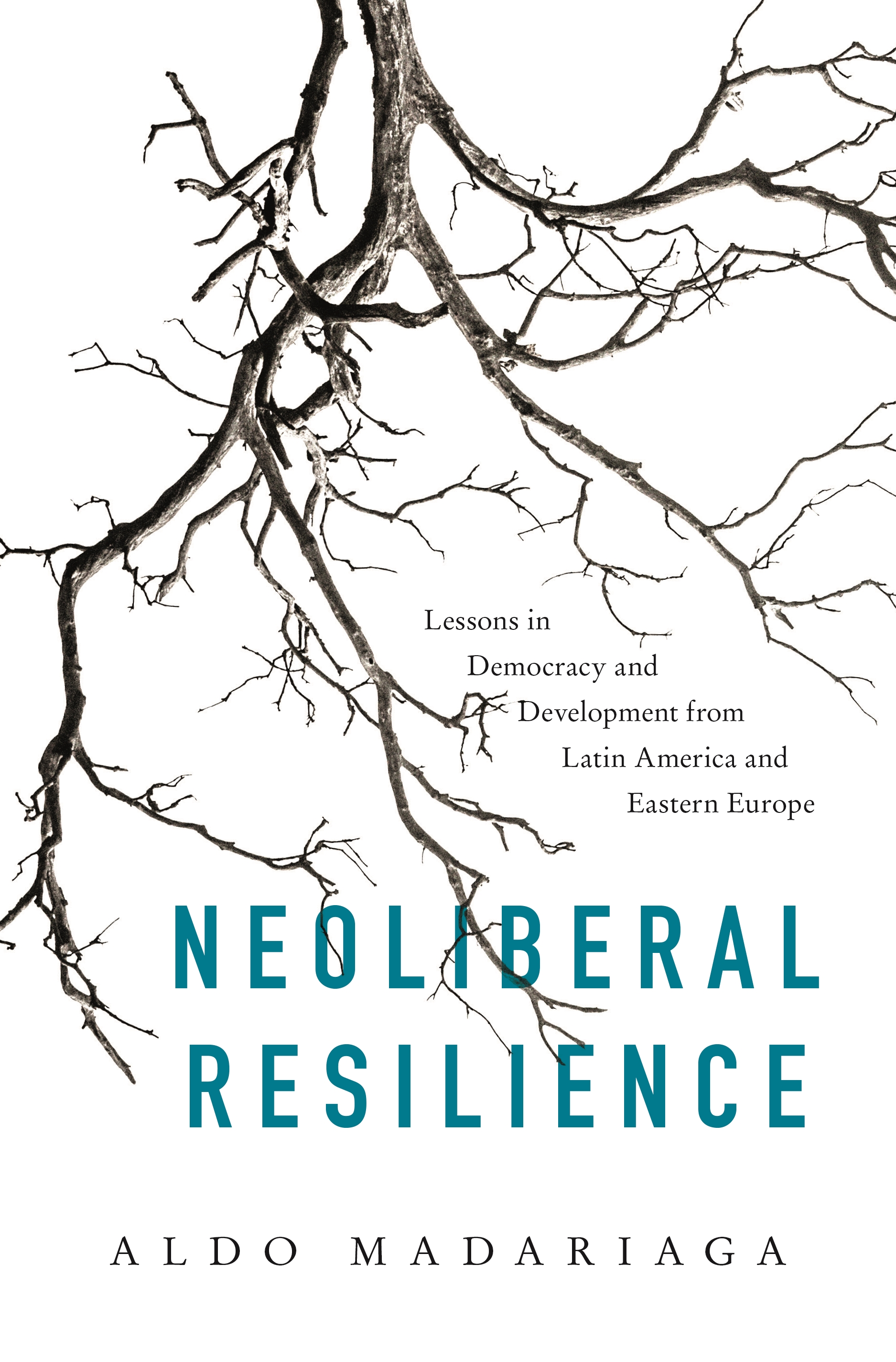
Neoliberal Resilience An exploration of the factors behind neoliberalism’s resilience in developing economies and what this could mean for democracy’s future Since the 1980s, neoliberalism has withstood repeated economic shocks and financial crises to become the hegemonic economic policy worldwide. Why has neoliberalism remained so resilient? What is the relationship between this resiliency and the backsliding of Western democracy? Can democracy survive an increasingly authoritarian neoliberal capitalism? Neoliberal Resilience answers these questions by bringing the developing world’s recent history to the forefront of our thinking about democratic capitalism’s future. Looking at four decades of change in four countries once considered to be leading examples of effective neoliberal policy in Latin America and Eastern Europe—Argentina, Chile, Estonia, and Poland—Aldo Madariaga examines the domestic actors and institutions responsible for defending neoliberalism. Delving into neoliberalism’s political power, Madariaga demonstrates that it is strongest in countries where traditional democratic principles have been slowly and purposefully weakened. He identifies three mechanisms through which coalitions of political, institutional, and financial forces have propagated neoliberalism’s success: the privatization of state companies to create a supporting business class, the use of political institutions to block the representation of alternatives in congress, and the constitutionalization of key economic policies to shield them from partisan influence. Madariaga reflects on today’s most pressing issues, including the influence of increasing austerity measures and the rise of populism. A comparative exploration of political economics at the peripheries of global capitalism, Neoliberal Resilience investigates the tensions between neoliberalism’s longevity and democracy’s gradual decline. POLITICAL SCIENCE,Political Economy

Global Political Economy Offering an accessible introduction to both the historical roots and the contemporary dynamics of today’s world economy, the extensively revised sixth edition of this bestselling textbook continues to lead the way in equipping students with the knowledge required to make sense of the fast-paced discipline of Global Political Economy. Illustrating the breadth of the subject, the book’s authors – both highly regarded experts in the field – show how the national and international interact, while also placing an emphasis on the historical evolution of the world economy in order to appreciate the nuances of today’s economic structures. The global economy is traced from the Industrial Revolution through each phase of a shifting world order to the modern day. Then follows an engaging exploration of the dynamics of today’s economy, including: trade, production, finance, labour, gender, development, the environment, security and governance. This takes into account the latest developments in the global economy, from automation and the challenges posed to the labour force, to artificial intelligence and the increasing complex, global supply chains of modern transnational firms. This is the most authoritative and accessible textbook on global political economy, making it the ideal companion for students at undergraduate and postgraduate levels, on Politics, International Relations and related degrees. POLITICAL SCIENCE,Political Economy
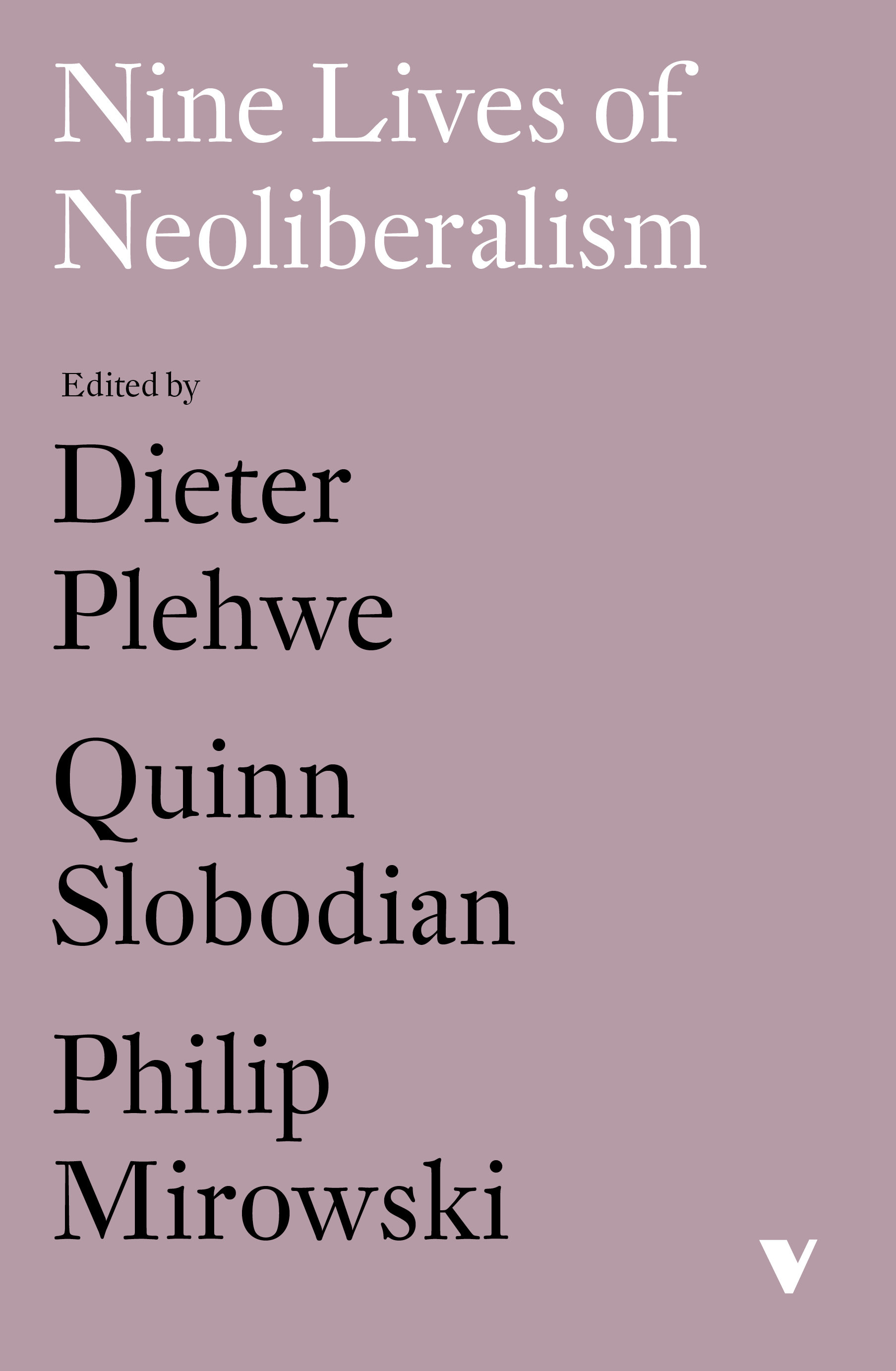
Nine Lives of Neoliberalism Untangling the long history of neoliberalism Neoliberalism is dead. Again. Yet the philosophy of the free market and the strong state has an uncanny capacity to survive, and even thrive, in times of crisis. Understanding neoliberalism’s longevity and its latest permutation requires a more detailed understanding of its origins and development. This volume breaks with the caricature of neoliberalism as a simple, unvariegated belief in market fundamentalism and homo economicus. It shows how neoliberal thinkers perceived institutions from the family to the university, disagreed over issues from intellectual property rights and human behavior to social complexity and monetary order, and sought to win consent for their project through the creation of new honors, disciples, and networks. Far from a monolith, neoliberal thought is fractured and, occasionally, even at war with itself. We can begin to make sense of neoliberalism’s nine lives only by understanding its own tangled and complex history. POLITICAL SCIENCE,Political Economy
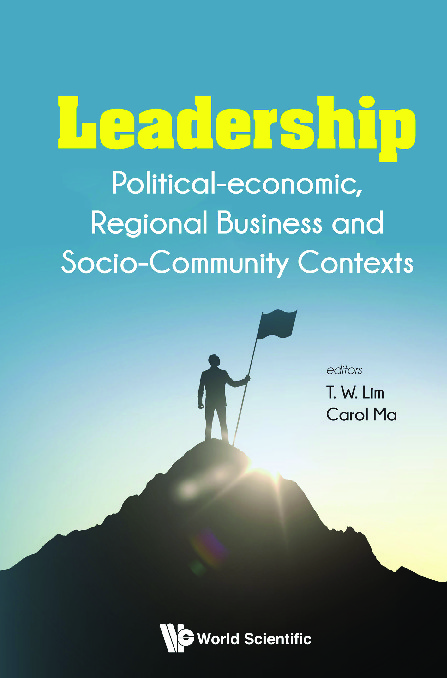
Leadership Political leadership styles in East Asian states are shaped and influenced by a number of domestic factors. These factors include the type of political system that an East Asian state adopted from their days of independence and decolonization. There is a diverse array of political systems in the region, ranging from Western-style liberal democracies like Japan and South Korea to autocratic one-party states like North Korea. Most other East Asian countries adopt systems somewhere in between these two polar ends. This volume begins with a macro-political perspective of leadership. It then looks at case studies of political leadership and the factors that influence the shape and outcome of leadership styles in the region.The book also examines the concept of community leadership and its impact on community well-being. Several specific case studies are examined in depth. While examining political leadership from a macro theoretical and empirical perspective, the book also adopts historical-anthropological perspectives to analyse case studies. The case studies also examine policy formulation and implementation to look at the role of government in handling community-level issues.Finally, the book focuses on economic leadership in international political economy and global business. POLITICAL SCIENCE,Political Economy
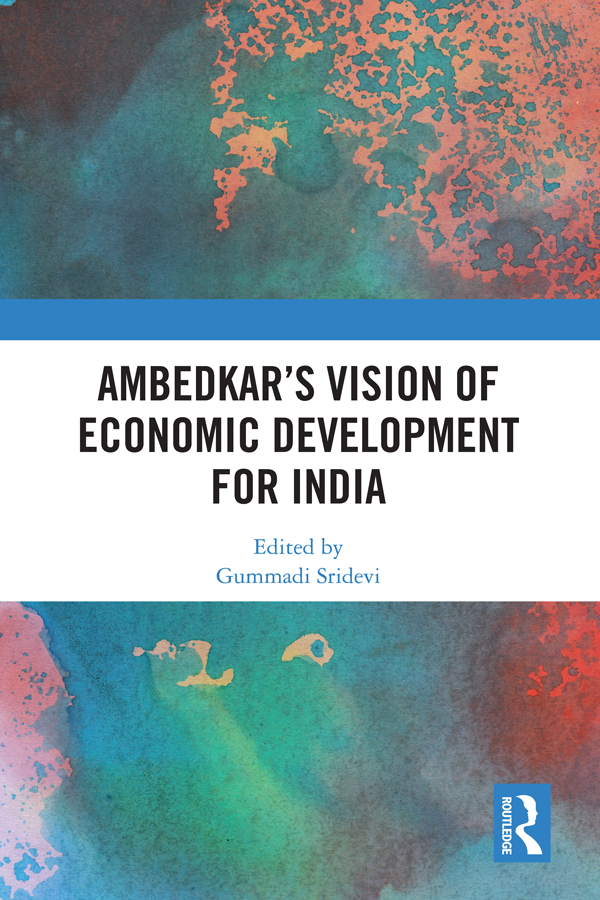
Ambedkar’s Vision of Economic Development for India This book discusses Ambedkar’s engagements with the issues of social justice, economic development and caste enclosures. It highlights his significant contributions in the field of trade, public finance and monetary economics, Indian agriculture, education, among others, and examines their relevance in contemporary India. The volume analyses the basic theoretical conceptions in Ambedkar’s writings which attributed a key role to industrialisation, favoured economic planning and progressive labour laws. It reaffirms these theories and illustrates that focus on social and economic democracy promotes productivity, equitable distribution of wealth and an inclusive society. Through an analysis of Ambedkar’s interdisciplinary works, the book discusses issues of rural poverty, lagging infrastructure growth, the persistence of an exploitative ruling class and the economic and social marginalisation of the downtrodden which are still relevant today. Further, it offers solutions for a restructuring of the society under democratic principles which would recognise the basic right of all to social dignity, and devise means to insure against social and economic insecurity. Insightful and authoritative, this volume will be of great interest to students and researchers of economics, sociology, development studies and social exclusion. POLITICAL SCIENCE,Political Economy
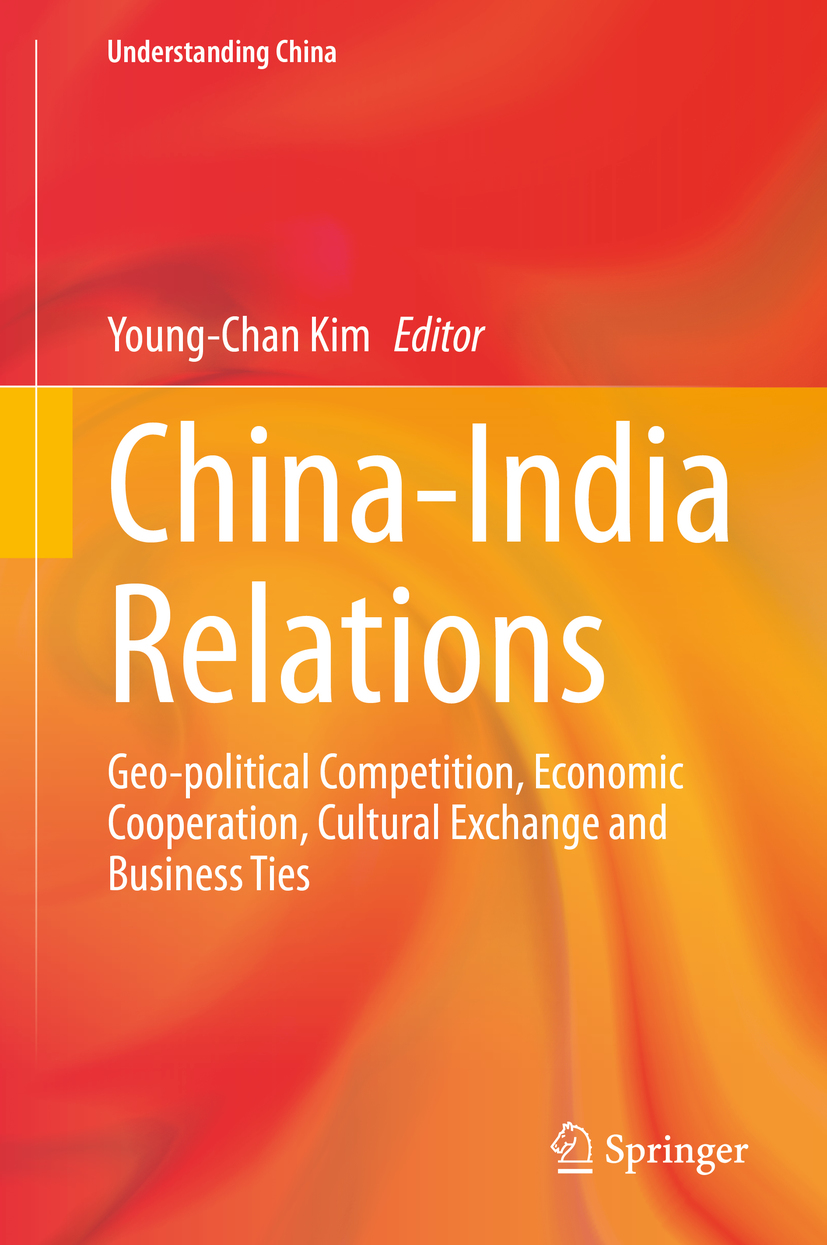
China-India Relations This book examines India-China relations throughout history as well as in the context of current business cooperation and competition. It also explores geo-political and societal factors, such as religion or class models, that influence and shape bilateral relations, and provides thorough analyses and comparisons of networks between the two countries. This book will appeal to researchers and graduate students interested in India-China relations as well as Chinese and Indian business ties. POLITICAL SCIENCE,Political Economy
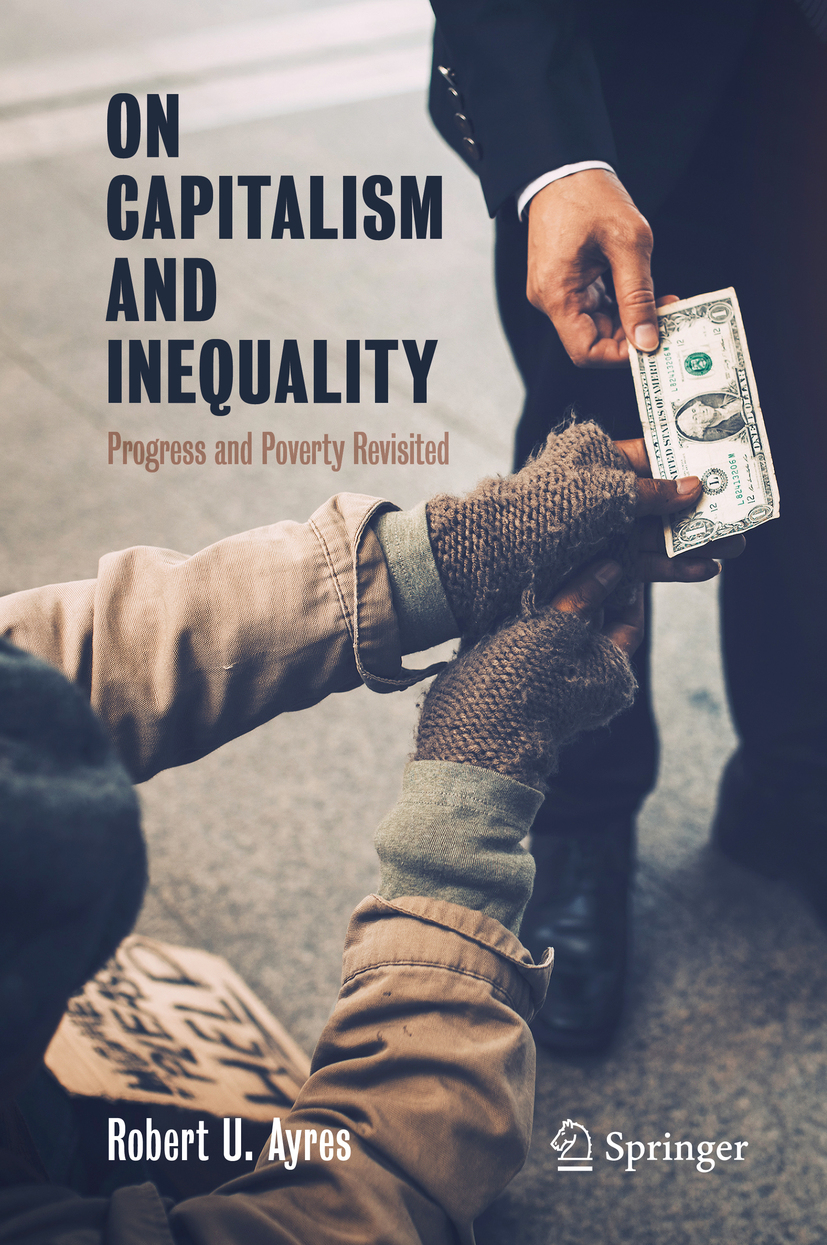
On Capitalism and Inequality Capitalism is under attack. Defenders say that capitalism has raised billions of people from poverty. But a central activity of capitalism today, Wall Street style, is speculation (gambling), using other people’s money, and privatizing the profits while socializing the debts. Skeptics argue that capitalism has redistributed the wealth of the planet in favor of a very few, meanwhile leaving the planet in bad shape and leaving billions of people out in the cold. Wealth is now extremely mal-distributed, opportunity is far from equal, and upward social mobility has declined significantly in recent decades. This book reviews the evidence and arguments pro and con in considerable detail.The evidence is mixed. The main virtue of capitalism is its emphasis on competition as a driver of innovation and, thus, of economic growth. It is true that economic growth has accelerated in recent centuries, and it is true that billions of people have been lifted from poverty. But it is not necessarily true that intense “winner take all†competition in the marketplace is the explanation for growth. Neoclassical economic theory posits that self-interest is the primary motive for all economic decisions, leaving little room for cooperation and even less for altruism. The theory applies to an unrealistic “model†of human behavior, known as Homo economicus or “economic manâ€, whose characteristic activity is buying or selling. The reason for using the adjective word “social†– as in socialism†or “social service†or “social democracy†-- is, essentially, to deny those postulates of standard economic theory. Real humans are not rational utility maximizers (whatever that is) and very often do things that are not in their own personal best interests. This can happen because other interests, such as family loyalty, professional, religious, or patriotic duty, may take precedence. Real people rarely behave like Homo economicus, who has rivals but no friends. He (or she) does not trust anyone, hence cannot cooperate with others, and can never create, or live in, a viable social system (or marriage). Yet social systems, ranging from families and tribes to firms, cities, and nations do (and must) exist or civilization cannot exist. A viable social system must not allow “winner takes allâ€. It must reallocate some of the societal wealth being created by competitive activities to support the young, the old and the weak, because all of those people have equal rights, if not the same luck or the same skills. Both competition and cooperation have important roles to play. A hybrid capitalism involving both is the only viable solution. The book ends with a specific suggestion, namely Universal Basic Income, or UBI. POLITICAL SCIENCE,Political Economy

Disruptive Technologies, Innovation and Development in Africa This book examines how disruptive technologies and innovation underpin the attainment of a broader development agenda in Africa. Contributors show how distinctive forms of technological innovation can impact critical development processes. For example, disruptive technologies can deepen the ongoing democratic and governance waves in Africa, specifically in the area of contested elections. Similarly, innovations in agriculture, the environment and energy promote changes in value chain agriculture, and the use of sensors to manage e-waste and sustainable energy conservation are also transforming established practices. Furthermore, the role of disruptive technologies and innovation in education, health, financial services and the nature of paid work cannot be ignored. Individually and collectively, the authors discuss and highlight the mechanisms and initiatives that can contribute to the realization of the development goals of African countries, especially in a period where disruptive technologies are rapidly changing how things are done. As a result, this book, which represents one of the most recent systematic efforts to bring together dialogue on disruptive technologies in Africa, will be of particular use and benefit to a wide and an eclectic audience. POLITICAL SCIENCE,Political Economy
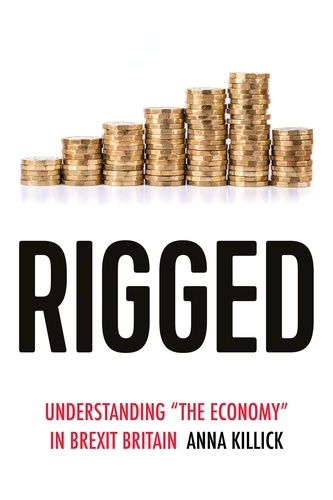
Rigged Most people find it hard to define 'the economy' beyond saying it is 'to do with money'. Through ethnographic research in a city on the South coast of England, this book explores what 'the economy' means to people's lives and what goes through their minds when they hear politicians talking about it. POLITICAL SCIENCE,Political Economy

Belt And Road Initiative And The World's Largest Small Commodity Market, The Located in the central Zhejiang province, Yiwu is a mountainous region originally inhabited by farmers. The poverty-stricken land left farmers with no option but commercial trading for a living. The city has a long history of being a hub for commercial trade. In the last two decades, the Yiwu international trade market has grown to be the world's largest small commodities market. This book studies the rapid development of 'Yiwu Business Circle' in the past two decades. Based on field research, the book analyzes the 'Yiwu Business Circle' from different levels such as the market system, supporting industry, merchant group and logistics network. The book also reveales the challenges and opportunities posed to 'Yiwu Business Circle' by the Belt and Road Initiative. It explores how the 'Yiwu Business Circle' will contribute to the Belt and Road Initiative by utilizing its strong business, logistics, capital and information flow platform that is established and shared by global manufacturers and merchants. POLITICAL SCIENCE,Political Economy
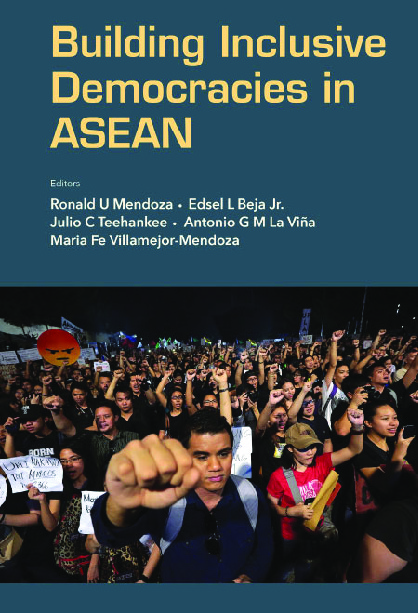
Building Inclusive Democracies In Asean Containing the latest research and insights of academics and development practitioners pursuing political and economic reforms in the ASEAN region, Building Inclusive Democracies in ASEAN recognizes that a well-functioning democracy is part of what ultimately fosters inclusive growth and development. Inequitable access to democratic processes and mechanisms produce government policies and initiatives that are inconsistent with the needs of the majority.The chapters include empirical research on the symptoms and effects of traditional patron-client politics, experiences, insights, analyses, and policy recommendations, as well as reflections, on reform efforts along the lines of citizens' participation, transparency, and evidence-based policymaking. POLITICAL SCIENCE,Political Economy

Power Concentration in World Politics This book discusses the role of space, time and cyclical behavior in world politics. More specifically, the political-economic role of lead economies – the world’s most innovative economies for finite periods of time – in world politics. These represent unusual concentrations of new technologies, energy sources, and military capabilities of global reach that play disproportional roles in the conduct of international affairs and the provision of limited governance at the most macro level. They also possess close links to economic growth and intense conflict. The book describes the economic, military and political processes behind the systemic leadership of a state at the international level. It also highlights the economic preconditions of systemic leadership, such as economic monopoly of new technologies and energy, which underlie the system leader’s material advantage over others. Analyzing lead economies and the evolution of power over a number of centuries, the author demonstrates how disruptions wrought by the emergence of new technologies and energy sources are partly responsible for global conflicts. This book appeals to international relations scholars as well as anyone interested in the political economy of systemic leadership, growth, and conflict in world politics. POLITICAL SCIENCE,Political Economy

Governance & Climate Justice This book examines international climate change mitigation and adaptation regimes with the aim of proposing fair climate stability implementation strategies. Based on the current endeavors to finance climate change mitigation and adaptation around the world, the author introduces a 3-dimensional climate justice approach to share the benefits and burdens of climate change equitably within society, across the globe and over time. POLITICAL SCIENCE,Political Economy
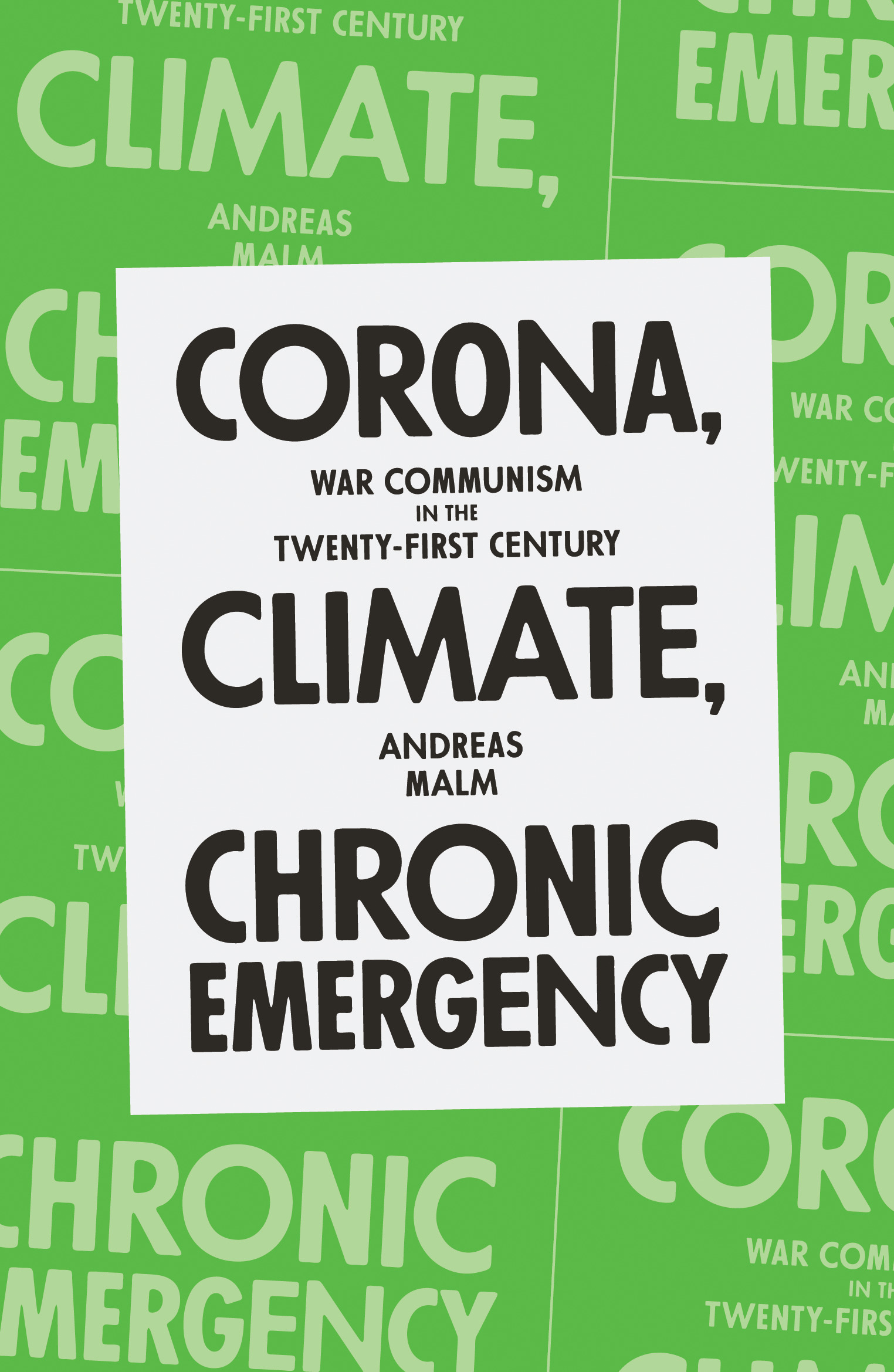
Corona, Climate, Chronic Emergency What does the COVID 19 tell us about the climate breakdown, and what should we do about it? The economic and social impact of the coronavirus pandemic has been unprecedented. Governments have spoken of being at war and find themselves forced to seek new powers in order to maintain social order and prevent the spread of the virus. This is often exercised with the notion that we will return to normal as soon as we can. What if that is not possible? Secondly, if the state can mobilize itself in the face of an invisible foe like this pandemic, it should also be able to confront visible dangers such as climate destruction with equal force. In Corona, Climate, Chronic Emergency, leading environmental thinker, Andreas Malm demands that this war-footing state should be applied on a permanent basis to the ongoing climate front line. He offers proposals on how the climate movement should use this present emergency to make that case. There can be no excuse for inaction any longer. POLITICAL SCIENCE,Political Economy
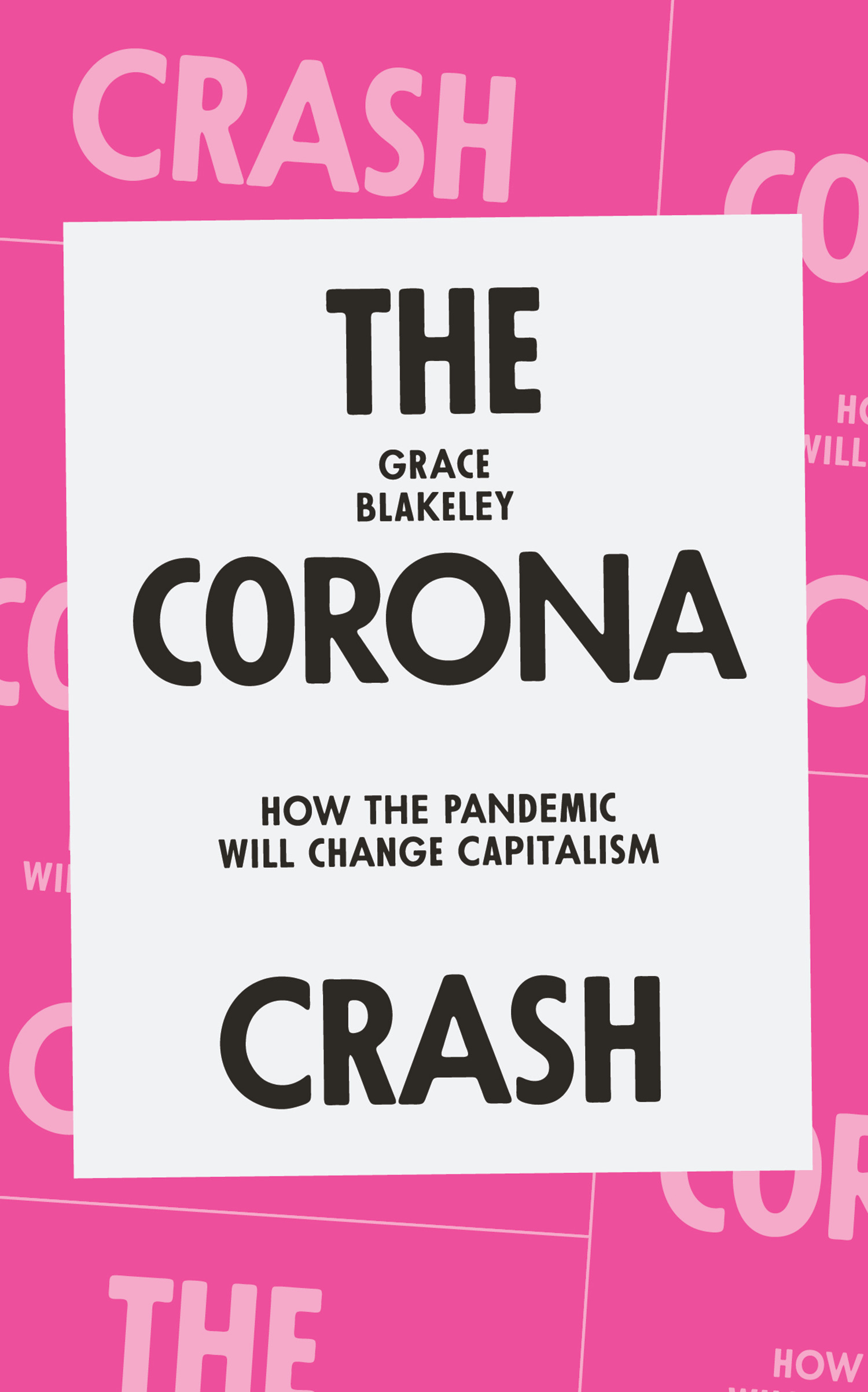
The Corona Crash Free market, competitive capitalism is dead. The separation between politics and economics can no longer be sustained. In The Corona Crash, leading economics commentator Grace Blakeley theorises about the epoch-making changes that the coronavirus brings in its wake. We are living through a unique moment in history. The pandemic has caused the deepest global recession since the Second World War. Meanwhile the human cost is reflected in a still-rising death toll, as many states find themselves unable—and some unwilling—to grapple with the effects of the virus. Whatever happens, we can never go back to business as usual. This crisis will tip us into a new era of monopoly capitalism, argues Blakeley, as the corporate economy collapses into the arms of the state, and the tech giants grow to unprecedented proportions. We need a radical response. The recovery could see the transformation of our political, economic, and social systems based on the principles of the Green New Deal. If not, the alternatives, as Blakeley warns, may be even worse than we feared. POLITICAL SCIENCE,Political Economy
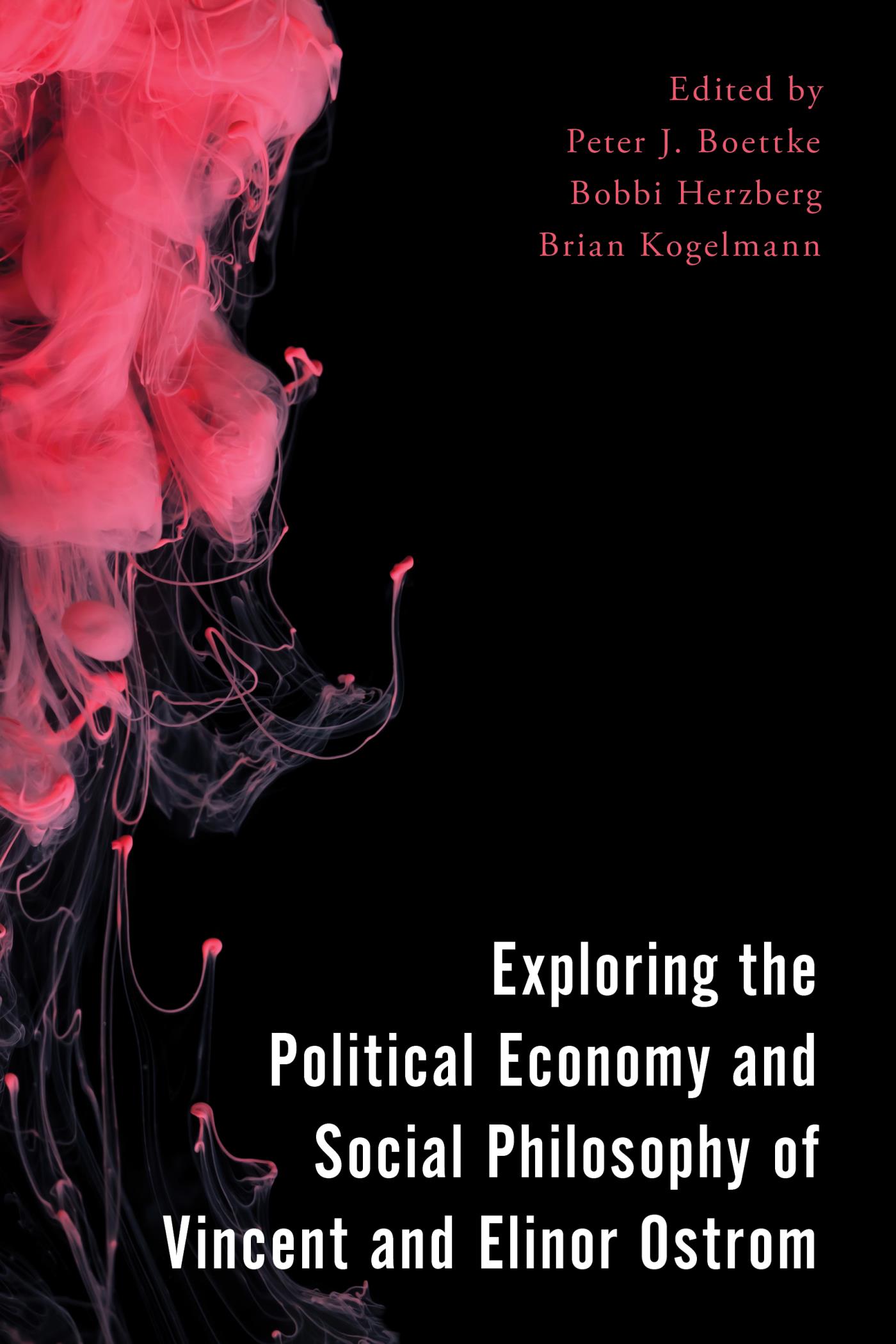
Exploring the Political Economy and Social Philosophy of Vincent and Elinor Ostrom This volume explores and engages with the work of Vincent and Elinor Ostrom, along with the Bloomington School of Political Economy more generally. POLITICAL SCIENCE,Political Economy
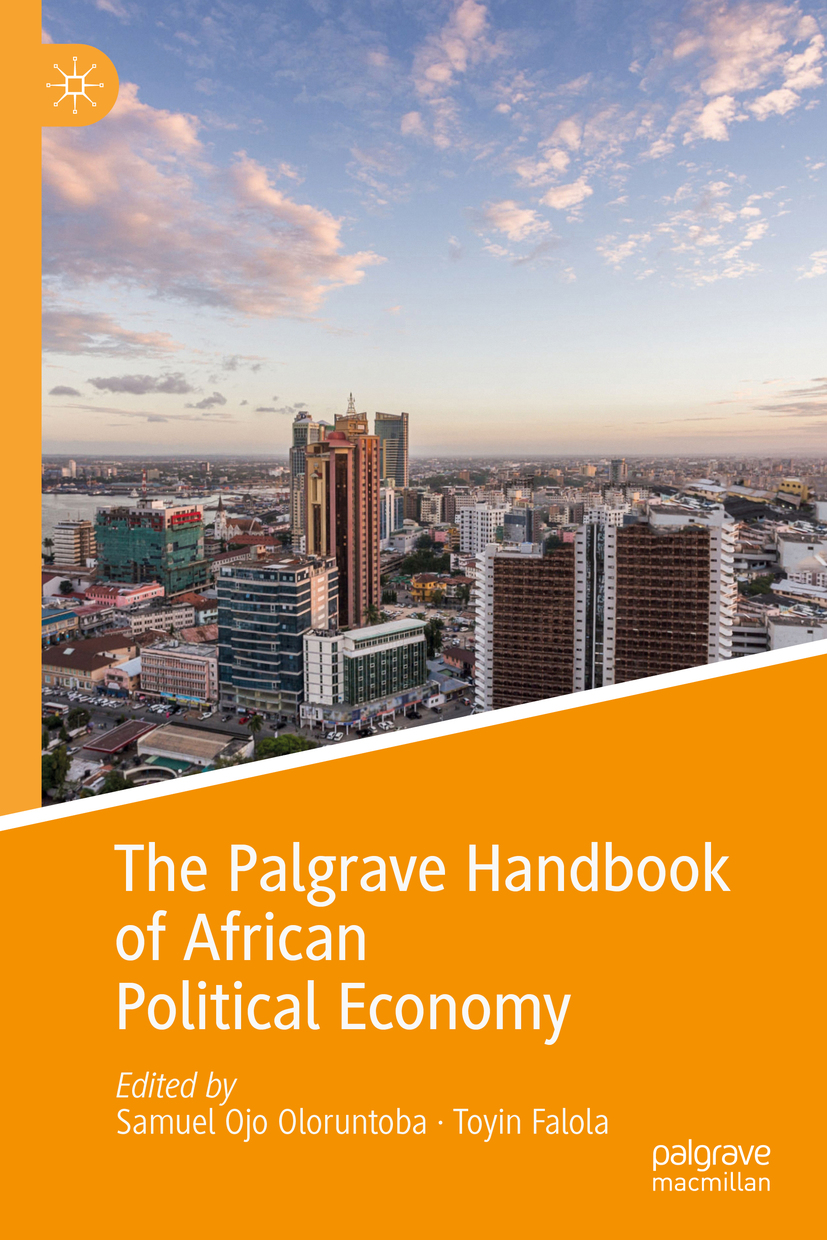
The Palgrave Handbook of African Political Economy This handbook constitutes a specialist single compendium that analyses African political economy in its theoretical, historical and policy dimensions. It emphasizes the uniqueness of African political economy within a global capitalist system that is ever changing and complex. Chapters in the book discuss how domestic and international political economic forces have shaped and continue to shape development outcomes on the continent. Contributors also provoke new thinking on theories and policies to better position the continent’s economy to be a critical global force. The uniqueness of the handbook lies in linking theory and praxis with the past, future, and various dimensions of the political economy of Africa. POLITICAL SCIENCE,Political Economy

Capitalism, Global Change and Sustainable Development This book analyzes new forms of capitalism that are manifesting under the pressures of global transformation. By studying economic and environmental indicators in various parts of the world, it seeks to reconcile economic growth with environmental and social sustainability, which is an important issue in both developed and emerging economies. These indicators include the explosive development of digital technologies and new global value chains, which are reshaping economies and societies all over the world. The contributing authors also address the challenge of immigration, the sustainable development transformation, the ties between productivity and social rights, automation and global value chains, the energy transition, and innovation and sustainable growth. POLITICAL SCIENCE,Political Economy

Economic Science Fictions An innovative new anthology exploring how science fiction can motivate new approaches to economics. From the libertarian economics of Ayn Rand to Aldous Huxley's consumerist dystopias, economics and science fiction have often orbited each other. In Economic Science Fictions, editor William Davies has deliberately merged the two worlds, asking how we might harness the power of the utopian imagination to revitalize economic thinking. Rooted in the sense that our current economic reality is no longer credible or viable, this collection treats our economy as a series of fictions and science fiction as a means of anticipating different economic futures. It asks how science fiction can motivate new approaches to economics and provides surprising new syntheses, merging social science with fiction, design with politics, scholarship with experimental forms. With an opening chapter from Ha-Joon Chang as well as theory, short stories, and reflections on design, this book from Goldsmiths Press challenges and changes the notion that economics and science fiction are worlds apart. The result is a wealth of fresh and unusual perspectives for anyone who believes the economy is too important to be left solely to economists. Contributors AUDINT, Khairani Barokka, Carina Brand, Ha-Joon Chang, Miriam Cherry, William Davies, Mark Fisher, Dan Gavshon-Brady and James Pockson, Owen Hatherley, Laura Horn, Tim Jackson, Mark Johnson, Bastien Kerspern, Nora O Murchú, Tobias Revell et al., Judy Thorne, Sherryl Vint, Joseph Walton, Brian Willems POLITICAL SCIENCE,Political Economy
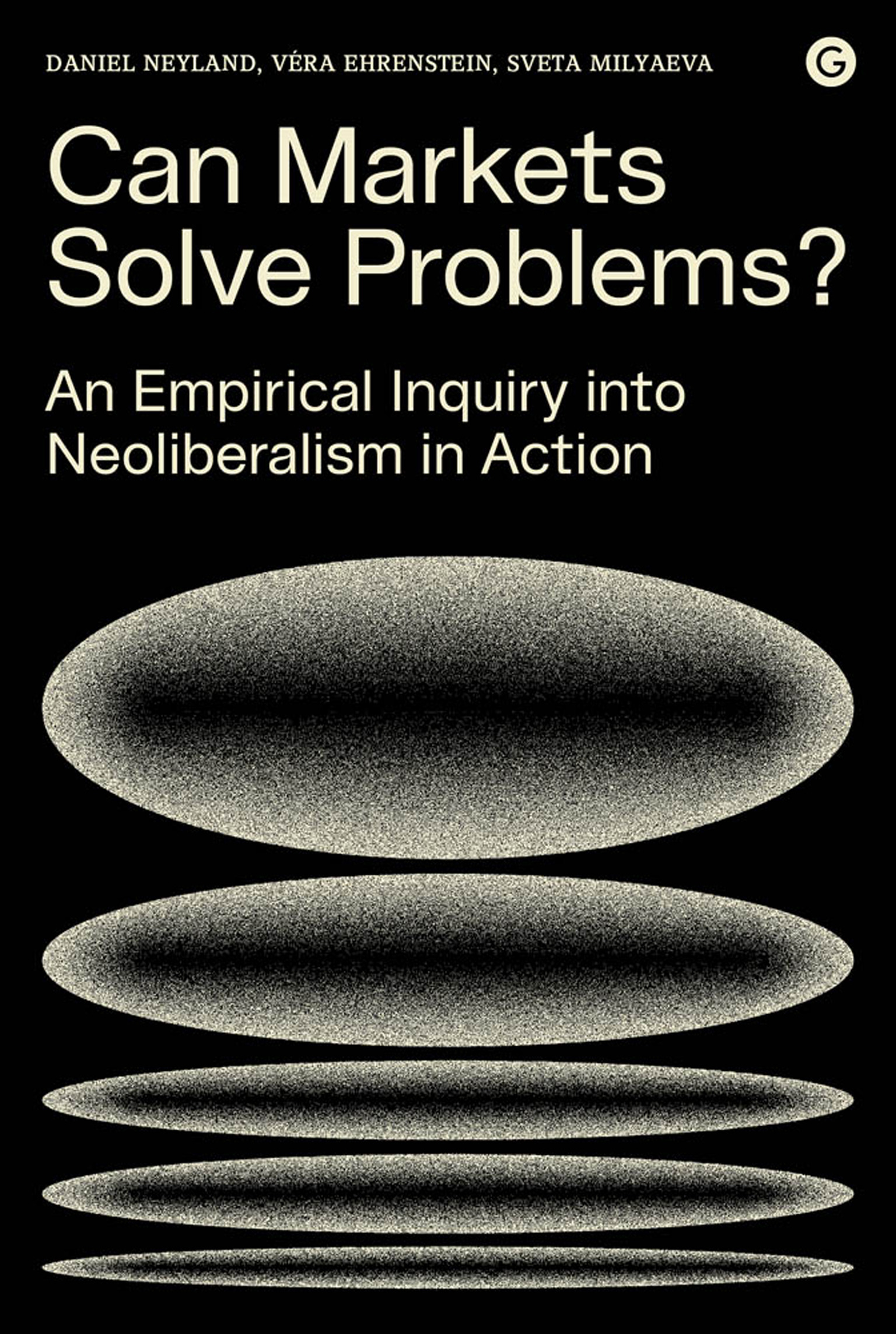
Can Markets Solve Problems? A provocative analysis of market-based interventions into public problems and the consequences. Market-based interventions have been used in attempts to solve numerous public problems, from education to healthcare and from climate change to privacy. Scholars have responded persuasively through critiques of neoliberalism. In Can Markets Solve Problems? Daniel Neyland, Véra Ehrenstein, and Sveta Milyaeva propose a different route forward. There is no single entity knowable as “the market,” the authors argue. Instead, they examine in detail the devices, relations, and practices that underpin these market-based interventions. Drawing on recent work in science and technology studies (STS), each chapter focuses on a different intervention and critically explores the market sensibility around which it is organized. Trade and exchange, competition, property and ownership, and investment and return all become the focus of a thorough exploration of what it means to intervene in public problems, how problems are composed, and how solutions are continually reworked. Can Markets Solve Problems? offers the first book-length STS enquiry into markets and public problems. Weaving together rich empirical descriptions and conceptual discussions, the book provides in-depth insights into the workings of these markets, their continuous evolution, and the consequences. The result is a new avenue of critical inquiry that moves between the details of specific policies and the always-emerging, collective features of this landscape of intervention. POLITICAL SCIENCE,Political Economy

Take Back the Center Reality-based arguments against right-wing fantasies: the case for reducing income inequality, rebuilding our infrastructure, investing in education, and putting people back to work. Midcentury America was governed from the center, a bipartisan consensus of politicians and public opinion that supported government spending on education, the construction of a vast network of interstate highways, healthcare for senior citizens, and environmental protection. These projects were paid for by a steeply progressive tax code, with a top tax rate at one point during the Republican Eisenhower administration of 91 percent. Today, a similar agenda of government action (and progressive taxation) would be portrayed as dangerously left wing. At the same time, radically anti-government and anti-tax opinions (with no evidence to support them) are considered part of the mainstream. In Take Back the Center, Peter Wenz makes the case for a sane, reality-based politics that reclaims the center for progressive policies. The key, he argues, is taxing the wealthy at higher rates. The tax rate for the wealthiest Americans has declined from the mid-twentieth-century high of 91 percent to a twenty-first-century low of 36 percent—even as social programs are gutted and the gap betweeen rich and poor widens dramatically. Ever since Ronald Reagan famously declared that government was the problem and not the solution, conservatives have had an all-purpose answer to any question: smaller government and lower taxes. Wenz offers an impassioned counterargument. He explains the justice of raising the top tax rates significantly, making a case for less income inequality (and countering society's worship of the wealthy), and he offers suggestions for how to spend the increased tax revenues: K-12 education, tuition relief, transportation and energy infrastructure, and universal health care. Armed with Wenz's evidence-driven arguments, progressives can position themselves where they belong: in the mainstream of American politics and at the center of American political conversations, helping their country address a precipitous decline in equality and quality of life. POLITICAL SCIENCE,Political Economy
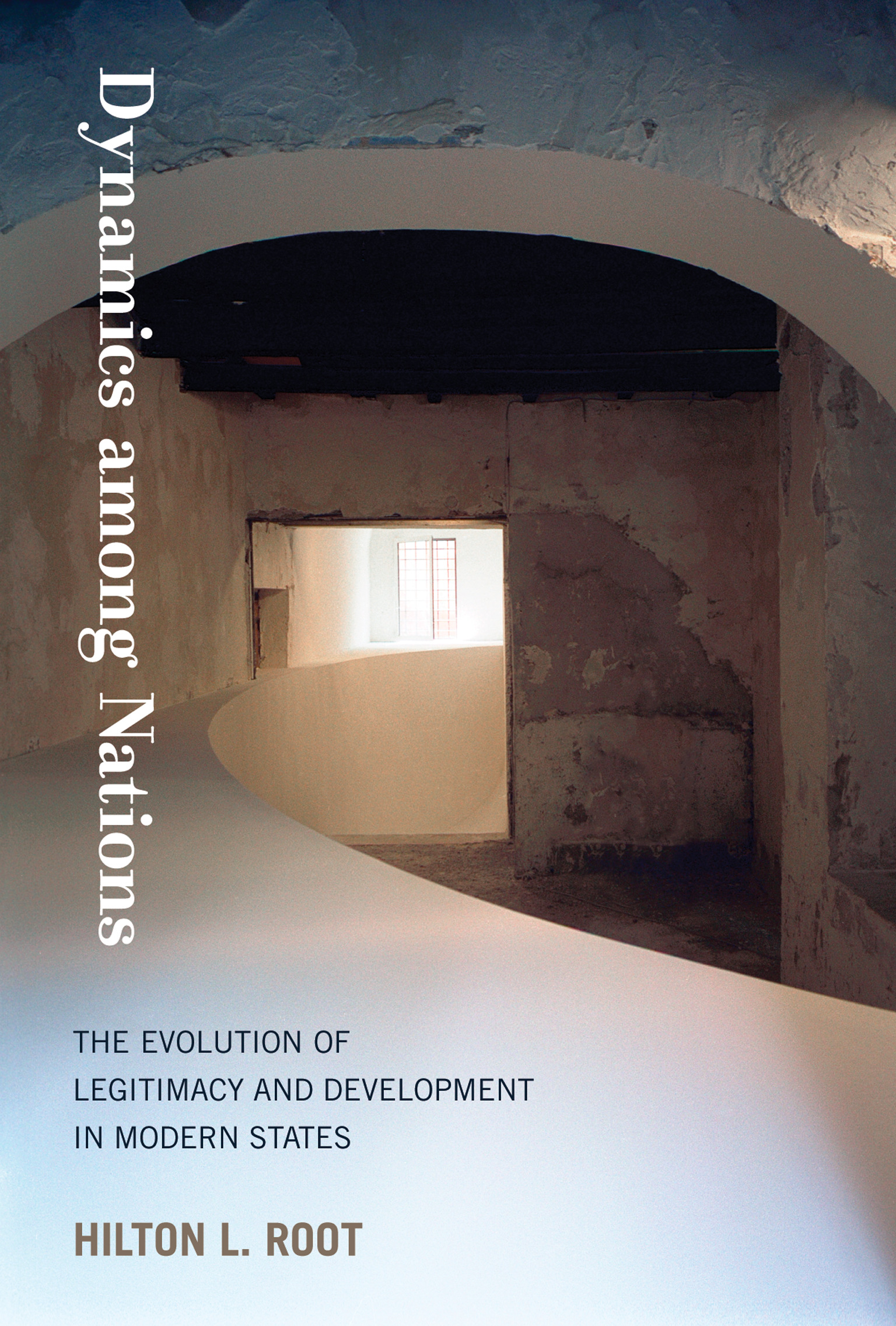
Dynamics among Nations An innovative view of the changing geopolitical landscape that draws on the science of complex adaptive systems to understand changes in global interaction. Liberal internationalism has been the West's foreign policy agenda since the Cold War, and the West has long occupied the top rung of a hierarchical system. In this book, Hilton Root argues that international relations, like other complex ecosystems, exists in a constantly shifting landscape, in which hierarchical structures are giving way to systems of networked interdependence, changing every facet of global interaction. Accordingly, policymakers will need a new way to understand the process of change. Root suggests that the science of complex systems offers an analytical framework to explain the unforeseen development failures, governance trends, and alliance shifts in today's global political economy. Root examines both the networked systems that make up modern states and the larger, interdependent landscapes they share. Using systems analysis—in which institutional change and economic development are understood as self-organizing complexities—he offers an alternative view of institutional resilience and persistence. From this perspective, Root considers the divergence of East and West; the emergence of the European state, its contrast with the rise of China, and the network properties of their respective innovation systems; the trajectory of democracy in developing regions; and the systemic impact of China on the liberal world order. Complexity science, Root argues, will not explain historical change processes with algorithmic precision, but it may offer explanations that match the messy richness of those processes. POLITICAL SCIENCE,Political Economy

The use of technology for the management of the EU/US Immigration andAsylum Policy- possible risks for fundamental rights protection Every single human being is becoming unintentionally more and more dependent on Information and Communication technologies. In a reality of ambient intelligence we all sacrifice our rights for the sake of convenience and security. POLITICAL SCIENCE,Political Economy
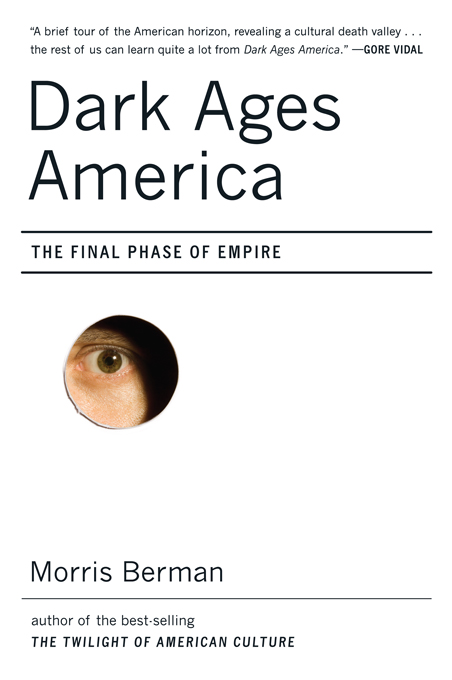
Dark Ages America In Dark Ages America, the pundit Morris Berman argues that the nation has entered a dangerous phase in its historical development from which there is no return. As the corporate-consumerist juggernaut that now defines the nation rolls on, the very factors that once propelled America to greatness—extreme individualism, territorial and economic expansion, and the pursuit of material wealth—are, paradoxically, the nails in our collective coffin. Within a few decades, Berman argues, the United States will be marginalized on the world stage, its hegemony replaced by China or the European Union. With the United States just one terrorist attack away from a police state, Berman's book is a controversial and illuminating look at our current society and its ills. POLITICAL SCIENCE,Political Economy
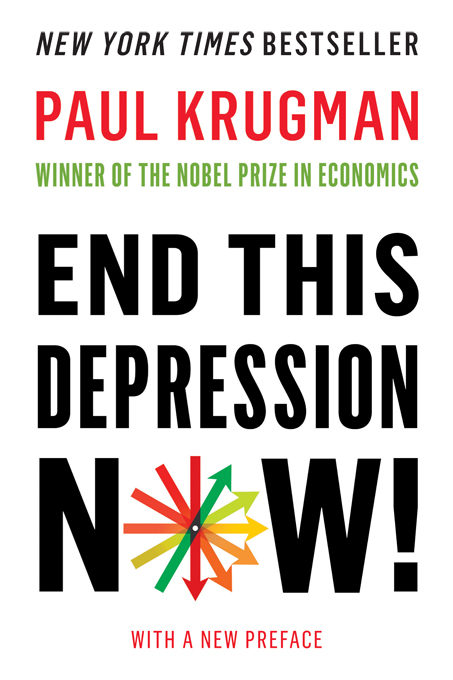
End This Depression Now! A New York Times best-selling call to arms from Nobel Prize–winning economist Paul Krugman. The Great Recession is more than four years old—and counting. Yet, as Paul Krugman points out in this powerful volley, "Nations rich in resources, talent, and knowledge—all the ingredients for prosperity and a decent standard of living for all—remain in a state of intense pain." How bad have things gotten? How did we get stuck in what now can only be called a depression? And above all, how do we free ourselves? Krugman pursues these questions with his characteristic lucidity and insight. He has a powerful message for anyone who has suffered over these past four years—a quick, strong recovery is just one step away, if our leaders can find the "intellectual clarity and political will" to end this depression now. POLITICAL SCIENCE,Political Economy
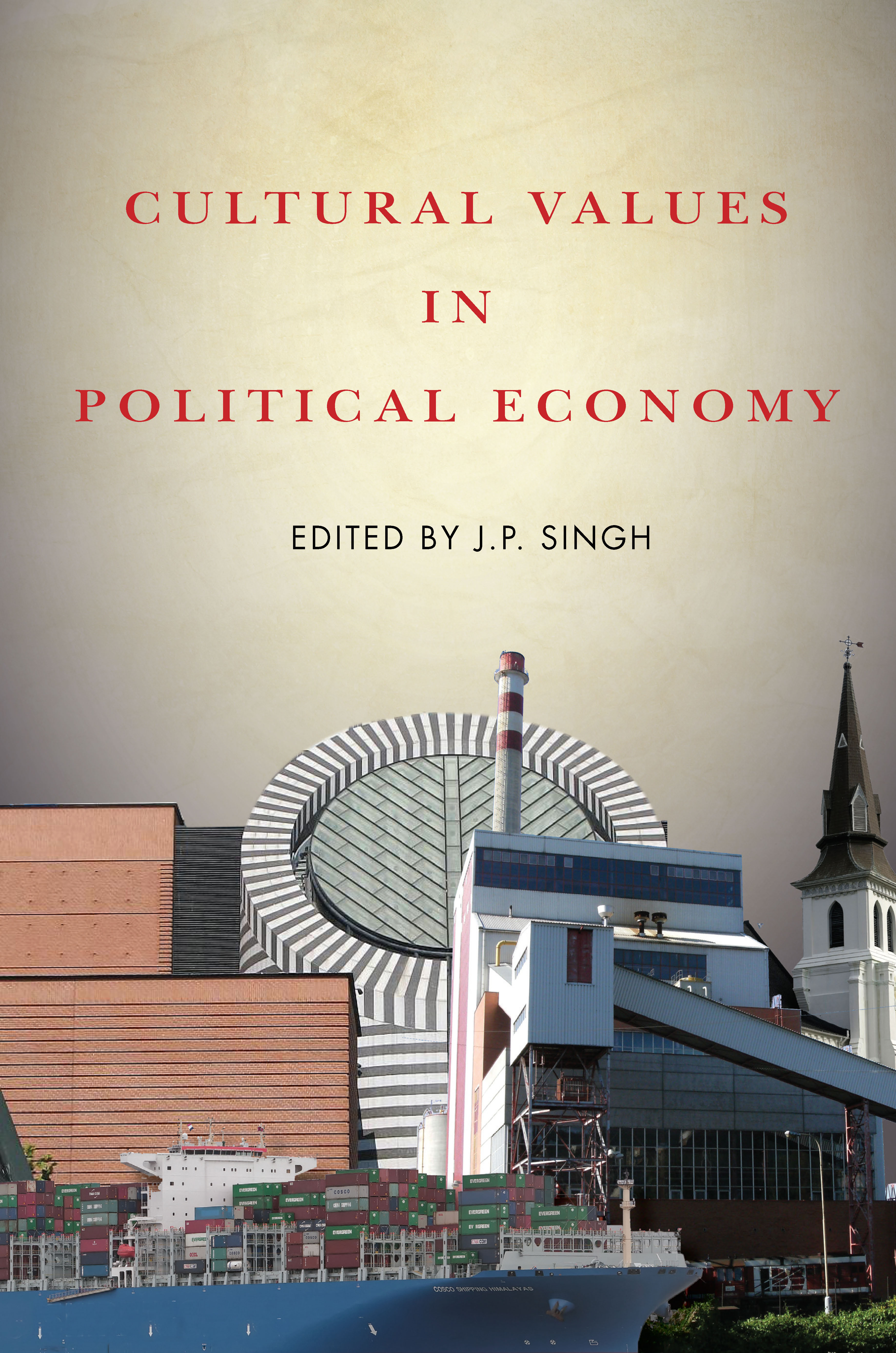
Cultural Values in Political Economy Featuring insights from a wide range of disciplines and a number of esteemed scholars, this volume explores cultural contexts that explain origins and changes in political economic interests and values. POLITICAL SCIENCE,Political Economy
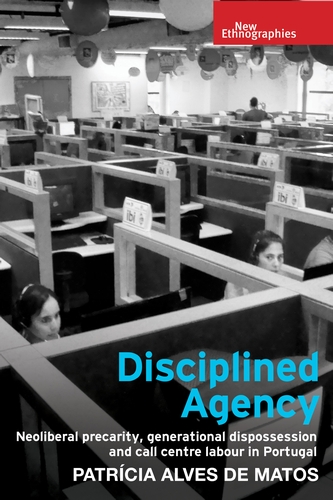
Disciplined agency Since the mid-2000s, the harsh reality of call centre employment for a generation of young workers in Portugal has been impossible to ignore. With its endless rows of small cubicles, where human agents endure repetitive telephone conversations with abusive clients under invasive modes of technological surveillance, discipline and control, call centre work remains a striking symbol of labour precarity, a condition particularly associated with the neoliberal generational disenchantment that ‘each generation does better than its predecessor’. This book describes the emergence of a regime of disciplined agency in the Portuguese call centre sector. Examining the ascendancy of call centres as icons of precarity in contemporary Portugal, this book argues that call centre labour constitutes a new form of commodification of the labouring subject. De Matos argues that call centres represent an advanced system of non-manual labour power exploitation, due to the underestimation of human creativity that lies at the centre of the regimented structures of call centre labour. Call centres can only guarantee profit maintenance, de Matos argues, through the commodification of the human agency arising from the operators’ moral, relational and social embedded agentive linguistic interventions of creative improvisation, decision-making, problem-solving and ethical evaluation. POLITICAL SCIENCE,Political Economy
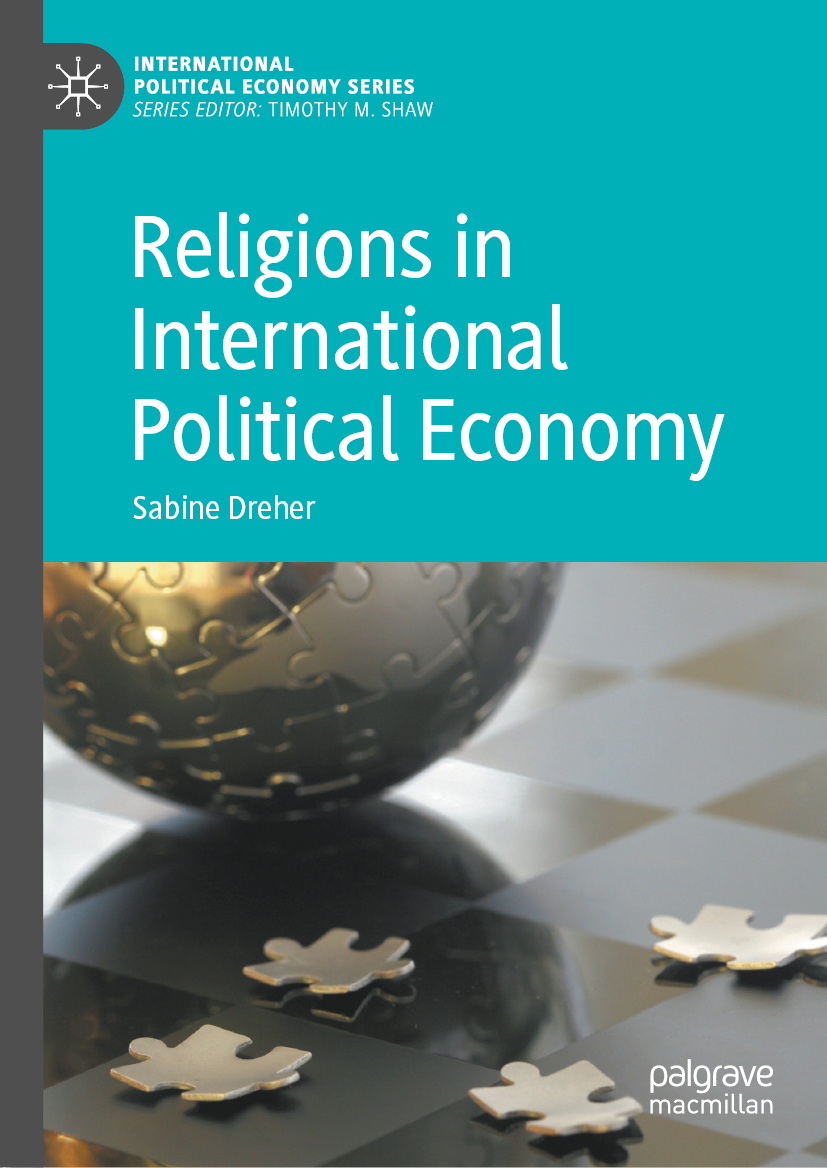
Religions in International Political Economy This book shows how religions and their internal struggles shape key actors and processes in the international political economy. It highlights how fundamentalist, business-oriented Christians in the United States were instrumental in the neoliberal turn in US hegemony, how Christianity, in the form of prosperity religion, transformed Latin America, and how reactionary religious movements sharpened state competition through illiberal politics in Turkey, India, and elsewhere. But reactionary movements are also confronted by liberationist or more progressive movements, such as Islamic feminism, that seek to build a more inclusive global economy. Religions and their ideas should be seen as a constitutive part of neoliberal globalization and its contestation in IPE. POLITICAL SCIENCE,Political Economy
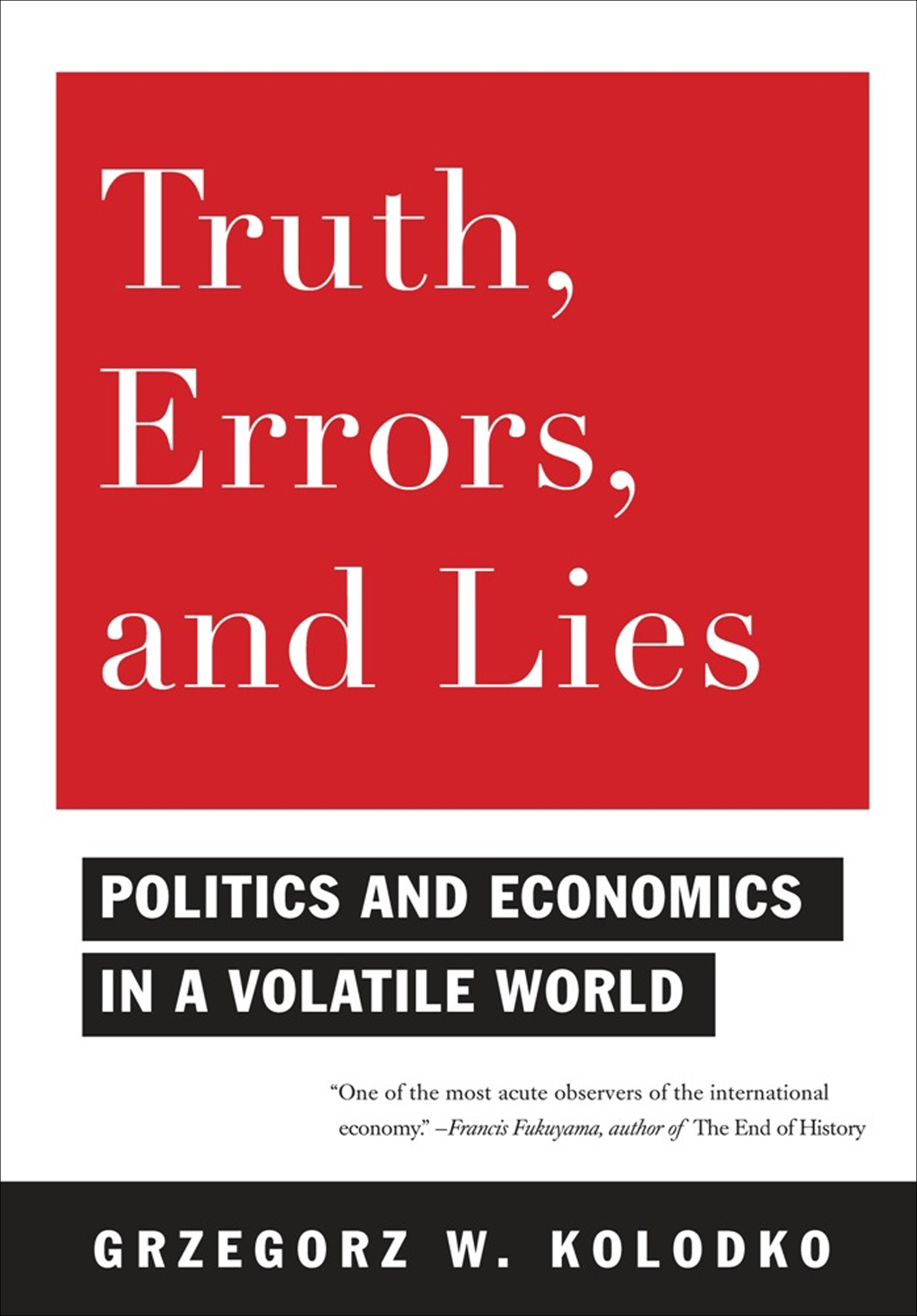
Truth, Errors, and Lies An approach to the challenges of globalism that rejects simplistic solutions, from “one of the most acute observers of the international economy†(Francis Fukuyama, New York Times-bestselling author of Identity). Deploying a novel mix of scientific evaluation and personal observation, Grzegorz W. Kolodko, one of the world’s leading authorities on economics and development policy, begins Truth, Errors, and Lies with a brief discussion of misinformation and its perpetuation in economics and politics. He criticizes the simplification of complex economic and social issues and investigates the link between developments in the global economy and cultural change, scientific discoveries, and political fluctuations. Kolodko, who was a key architect of Poland’s successful reforms, offers a provocative study of globalization and the possibility of coming out ahead in an era of worldwide interdependence. Deeply critical of neoliberalism, which sought to transfer economic control exclusively to the private sector, Kolodko explores the virtues of social-economic development and the new rules of the economic game. He concludes with a look at our near and distant future, questioning whether we have a say in its making. “One of the heavyweight economic thinkers of post-communist Europe.â€â€”The Economist Nominated for the Michael Harrington Book Award POLITICAL SCIENCE,Political Economy

Building the New American Economy The influential economist offers a persuasive strategy for a more just and sustainable economy—with a forward by Bernie Sanders. The New York Times has said that Jeffrey D. Sachs is “probably the most important economist in the world.†Now, in a book that combines impassioned manifesto with a plan of action, Sachs charts a path to move America toward sustainable development. Sustainable development is a holistic approach to public policy that unifies economic, social, and environmental objectives. By focusing too much on short-term economic growth, the United States has neglected rising inequality and dire environmental threats—all while putting our long-term economic growth at risk. Sachs explores issues that have captivated national discourse, including infrastructure, trade deals, energy policy, the proper size and role of government, the national debt, and income inequality. In accessible language, he illuminates the forces at work in each case and presents specific policy solutions. His argument rises above the stagnation of partisanship to envision a brighter way forward both individually and collectively. “Sachs demonstrates expertise on vastly different policy fields and makes a convincing case that abdicating the toxic intersection of militarism and exceptionalism is key to building a brighter future.â€â€”Global Policy Journal POLITICAL SCIENCE,Political Economy
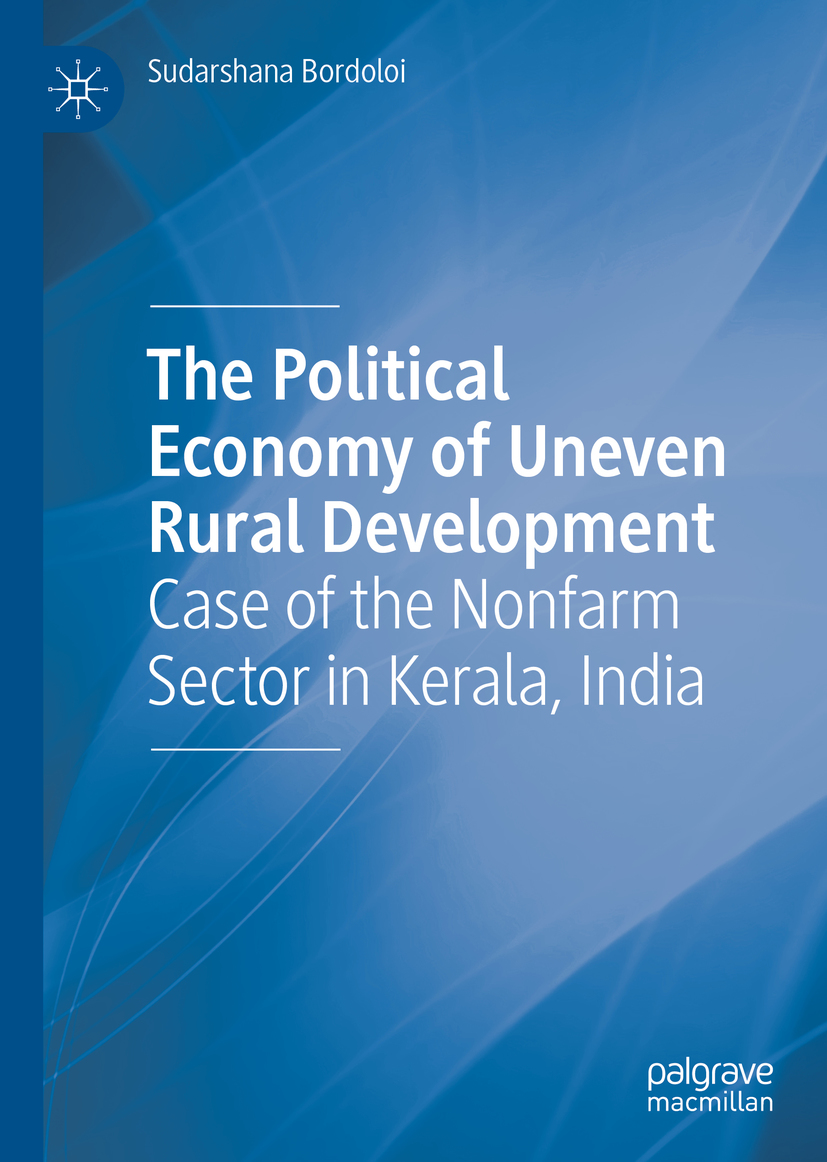
The Political Economy of Uneven Rural Development The book shows how class relations develop and is a consequence of capitalist development of the rural non-agricultural/non-farm sector (RNFS)---seen as the dialectical relation between the forces and relations of production---as mediated by the state, which produces uneven social and spatial outcomes. Central to the framework for this book are four inter-related conceptual building blocks or themes: social relations of production, productive forces, role of the state and concrete development outcomes of capitalist production in RNFS in the context of class and non-class relations of oppressions. These four conceptual themes follow a logical sequence where each concept evolve in specific contexts within the RNFS; while connected to each other in a dialectical manner; and come together to form the central argument of the book. POLITICAL SCIENCE,Political Economy

Privacy Lost While other books in the field focus on specific aspects of privacy or how to avoid invasions, David H. Holtzman--a master technologist, internet pioneer, security analyst, and former military codebreaker--presents a comprehensive insider's exposé of the world of invasive technology, who's using it, and how our privacy is at risk. Holtzman starts out by categorizing privacy violations into "The 7 Sins Against Privacy" and then goes on to explain in compelling and easy to understand language exactly how privacy is being eroded in every aspect of our lives. Holtzman vividly reveals actual invasions and the dangers associated with the loss of privacy, and he takes a realistic look at the trade offs between privacy and such vital issues as security, rights, and economic development. Praise for Privacy Lost "Whether we know it or not, we have all become citizens of the Digital Age. As such we need to take responsibility for our conduct, our safety, and our privacy. David Holtzman is deeply knowledgeable about the industry and passionate about the issues. Regardless of your political views, you will come away from this book better equipped to meet the challenges before us all." --Geoffrey A. Moore, author, Dealing with Darwin: How Great Companies Innovate at Every Phase of Their Evolution "Holtzman has drafted a blueprint all citizens of this great land ought to read if they desire to understand what privacy truly means, why it is important to both their everyday life as well as to their understanding of what it really means to be free, and what they can do to salvage what little privacy is left them. Privacy Lost needs to be readily available on the desks of all concerned citizens--heavily dog-eared and underlined." --Bob Barr, practicing attorney and former Member of theUnited States House of Representatives POLITICAL SCIENCE,Political Freedom
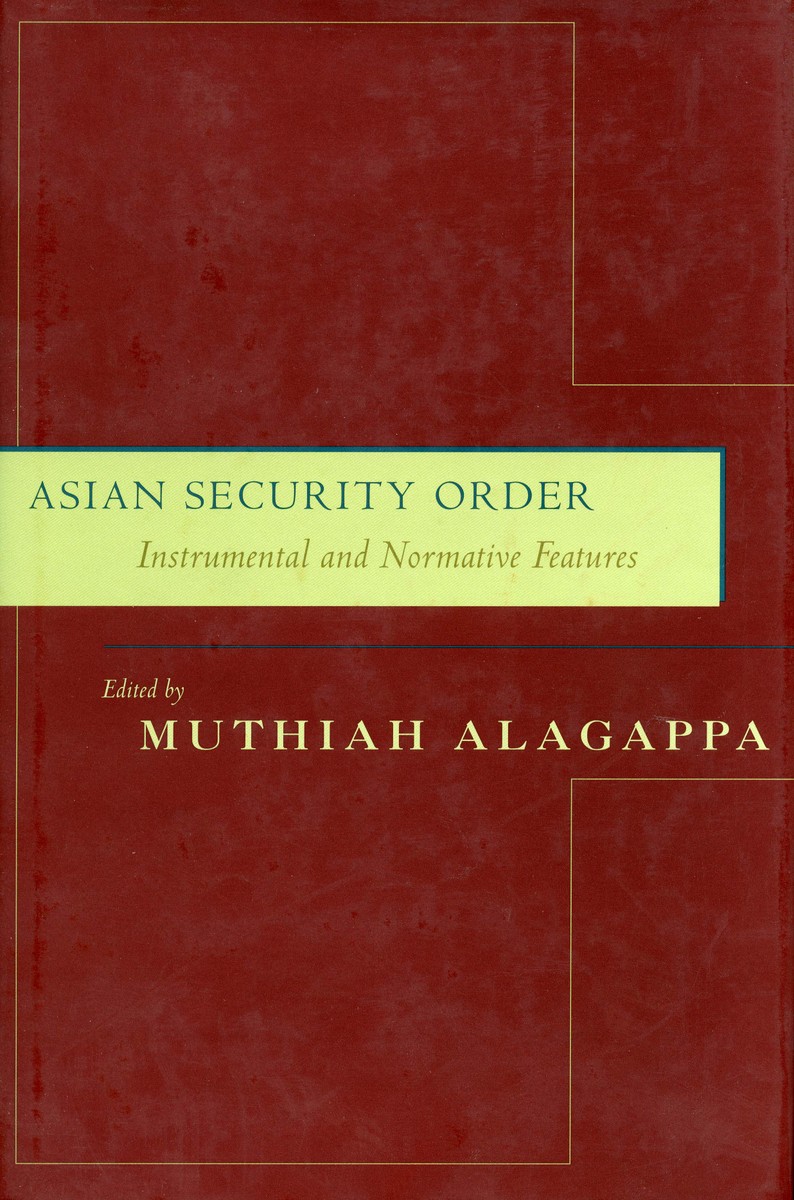
In Defense of Japan This book provides the first full-blown, up-to-date, English-language based narrative on the history, politics, and policy of Japan's strategic space development. POLITICAL SCIENCE,Political Freedom
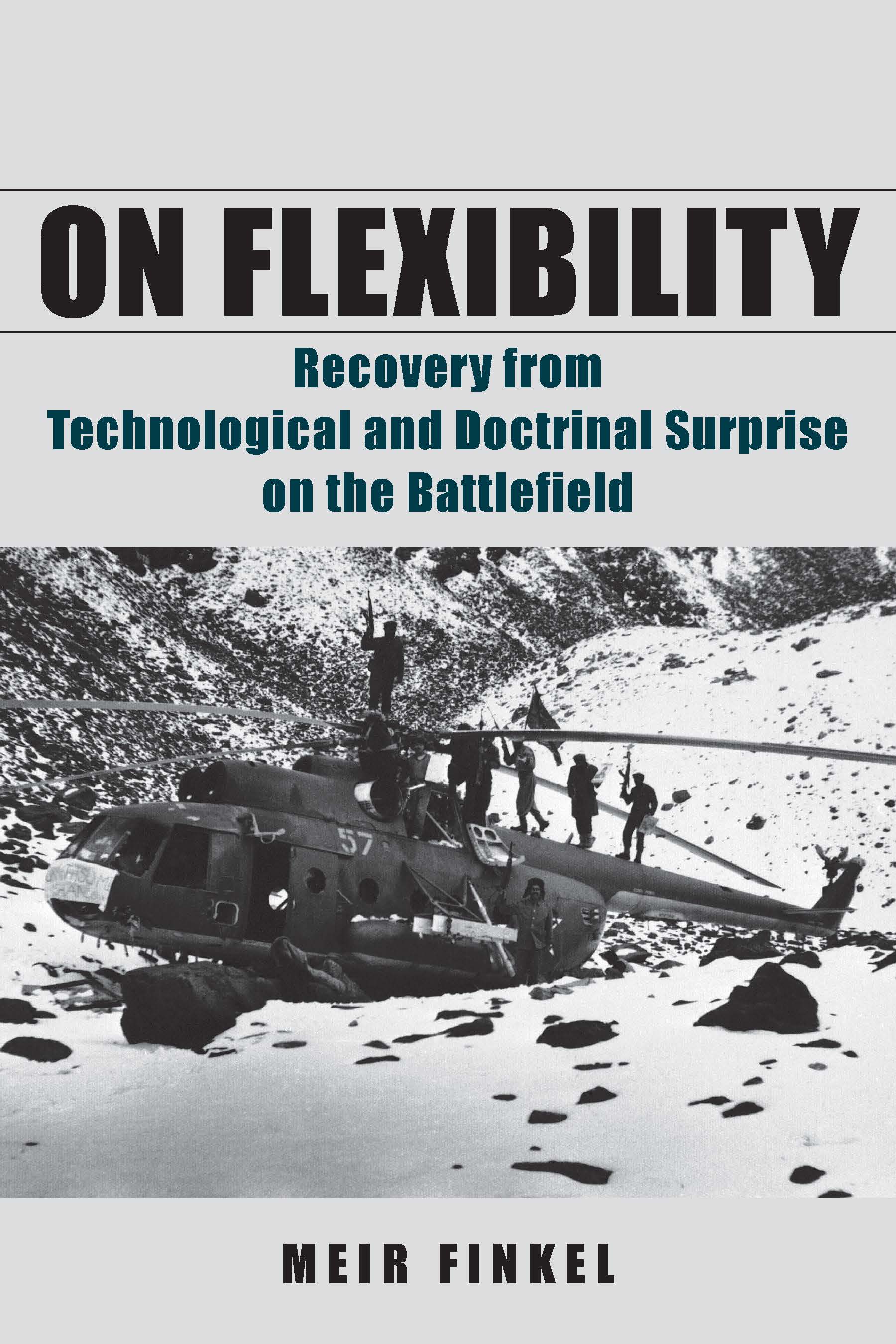
On Flexibility On Flexibility presents a force planning concept that will enable armies to cope with the growing diversity of battlefield requirements, and especially with technological and doctrinal surprises, through applied adaptability and flexibility, minimizing the over dependence on intelligence and prediction involved in this process today. POLITICAL SCIENCE,Political Freedom

Transforming Command The book tells the story of the theory and history of the mission command approach (decentralized command) and the attempts by different armies to adopt and reform according to this approach. POLITICAL SCIENCE,Political Freedom
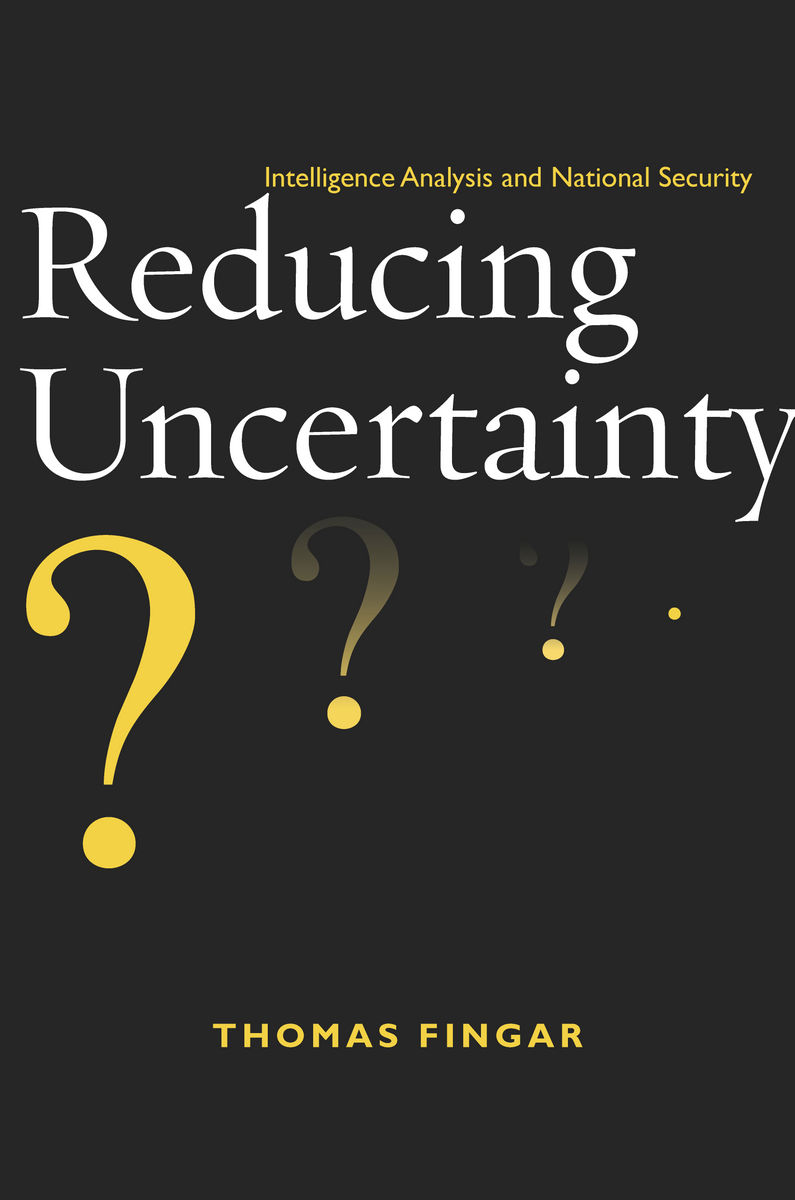
Reducing Uncertainty This book describes what Intelligence Community (IC) analysts do, how they do it, and how they are affected by the political context that shapes, uses, and sometimes abuses their output. It is written by a 25-year intelligence professional. POLITICAL SCIENCE,Political Freedom
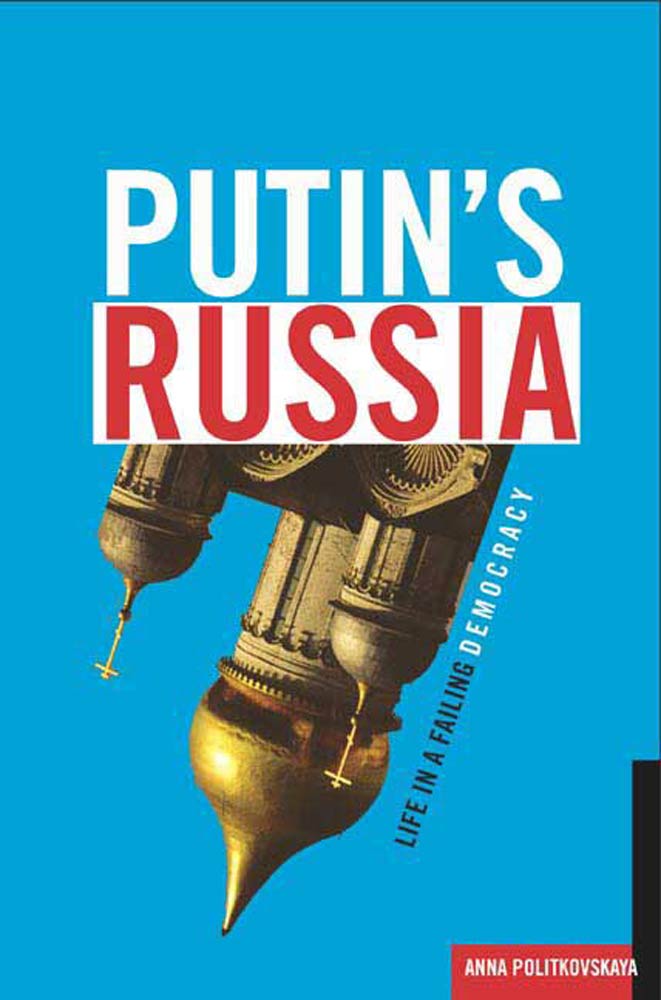
Putin's Russia A searing portrait of a country in disarray and of the man at its helm, from "the bravest of Russian journalists" (The New York Times) Hailed as "a lone voice crying out in a moral wilderness" (New Statesman), Anna Politkovskaya made her name with her fearless reporting on the war in Chechnya. Now she turns her steely gaze on the multiple threats to Russian stability, among them Vladimir Putin himself. Rich with characters and poignant accounts, Putin's Russia depicts a far-reaching state of decay. Politkovskaya describes an army in which soldiers die from malnutrition, parents must pay bribes to recover their dead sons' bodies, and conscripts are even hired out as slaves. She exposes rampant corruption in business, government, and the judiciary, where everything from store permits to bus routes to court appointments is for sale. And she offers a scathing condemnation of the ongoing war in Chechnya, where kidnappings, extra-judicial killings, rape, and torture are begetting terrorism rather than fighting it. Finally, Politkovskaya denounces both Putin, for stifling civil liberties as he pushes the country back to a Soviet-style dictatorship, and the West, for its unqualified embrace of the Russian leader. Sounding an urgent alarm, Putin's Russia is a gripping portrayal of a country in crisis and the testament of a great and intrepid reporter. POLITICAL SCIENCE,Political Freedom

The End of Intelligence Using espionage as a test case, The End of Intelligence criticizes claims that the recent information revolution has weakened the state, revolutionized warfare, and changed the balance of power between states and non-state actors—and it assesses the potential for realizing any hopes we might have for reforming intelligence and espionage. Examining espionage, counterintelligence, and covert action, the book argues that, contrary to prevailing views, the information revolution is increasing the power of states relative to non-state actors and threatening privacy more than secrecy. Arguing that intelligence organizations may be taken as the paradigmatic organizations of the information age, author David Tucker shows the limits of information gathering and analysis even in these organizations, where failures at self-knowledge point to broader limits on human knowledge—even in our supposed age of transparency. He argues that, in this complex context, both intuitive judgment and morality remain as important as ever and undervalued by those arguing for the transformative effects of information. This book will challenge what we think we know about the power of information and the state, and about the likely twenty-first century fate of secrecy and privacy. POLITICAL SCIENCE,Political Freedom

Fair Play Revolutionary War officer Nathan Hale, one of America’s first spies, said, “Any kind of service necessary to the public good becomes honorable by being necessary.†A statue of Hale stands outside CIA headquarters, and the agency often cites his statement as one of its guiding principles. But who decides what is necessary for the public good, and is it really true that any kind of service is permissible for the public good? These questions are at the heart of James M. Olson’s book, Fair Play: The Moral Dilemmas of Spying. Olson, a veteran of the CIA’s clandestine service, takes readers inside the real world of intelligence to describe the difficult dilemmas that field officers face on an almost daily basis. Far from being a dry theoretical treatise, this fascinating book uses actual intelligence operations to illustrate how murky their moral choices can be. Readers will be surprised to learn that the CIA provides very little guidance on what is, or is not, permissible. Rather than empowering field officers, the author has found that this lack of guidelines actually hampers operations. Olson believes that U.S. intelligence officers need clearer moral guidelines to make correct, quick decisions. Significantly, he believes these guidelines should come from the American public, not from closed-door meetings inside the intelligence community. Fair Play will encourage a broad public debate about the proper moral limits on U.S. intelligence activities. POLITICAL SCIENCE,Political Freedom

Wages of Rebellion Revolutions come in waves and cycles. We are again riding the crest of a revolutionary epic, much like 1848 or 1917, from the Arab Spring to movements against austerity in Greece to the Occupy movement. In Wages of Rebellion, Chris Hedges -- who has chronicled the malaise and sickness of a society in terminal moral decline in his books Empire of Illusion and Death of the Liberal Class -- investigates what social and psychological factors cause revolution, rebellion, and resistance. Drawing on an ambitious overview of prominent philosophers, historians, and literary figures he shows not only the harbingers of a coming crisis but also the nascent seeds of rebellion. Hedges' message is clear: popular uprisings in the United States and around the world are inevitable in the face of environmental destruction and wealth polarization. Focusing on the stories of rebels from around the world and throughout history, Hedges investigates what it takes to be a rebel in modern times. Utilizing the work of Reinhold Niebuhr, Hedges describes the motivation that guides the actions of rebels as "sublime madness" -- the state of passion that causes the rebel to engage in an unavailing fight against overwhelmingly powerful and oppressive forces. For Hedges, resistance is carried out not for its success, but as a moral imperative that affirms life. Those who rise up against the odds will be those endowed with this "sublime madness." From South African activists who dedicated their lives to ending apartheid, to contemporary anti-fracking protests in Alberta, Canada, to whistleblowers in pursuit of transparency, Wages of Rebellion shows the cost of a life committed to speaking the truth and demanding justice. Hedges has penned an indispensable guide to rebellion. POLITICAL SCIENCE,Political Freedom

De-Radicalisation in the UK Prevent Strategy This book examines de-radicalisation policy in the UK and addresses the contradictions evident in the conceptualisation and practice of de-radicalisation. It explores three main themes that touch upon some of the most pressing issues of our day: security, identity and religion. Situated within the Prevent strand of the UK Counter-Terrorism policy and administered by the police through the ‘Channel Programme’, policymakers have promoted de-radicalisation as a vital instrument in the fight against terrorism. Despite the political and legal importance of de-radicalisation as an instrument of counter-terrorism, we continue to know very little about the programme and the profile of individuals who have been de-radicalised, as well as having little or no access to data on the programme. There is also a glaring lacuna in the wider literature regarding the concept, theory, and evidence base for de-radicalisation policies. This book addresses this lacuna and, with the use of data collected from interviews conducted with 27 practitioners, this work reveals the existence of multiple conceptions of de-radicalisation and a number of conceptual features unique to the UK context. Subsequently, the book proposes that de-radicalisation in the UK would be best conceptualised as ‘technologies of the self’. Seen in this way, de-radicalisation is less about tackling terrorism and radicalisation and more about the re-configuring of citizenship, the construction of a mainstream British identity, and the promotion of certain subjectivities in an era of uncertainty about British political identity. This book will be of much interest to students of critical terrorism studies, de-radicalisation, counter-terrorism, UK politics and security studies in general. POLITICAL SCIENCE,Political Freedom
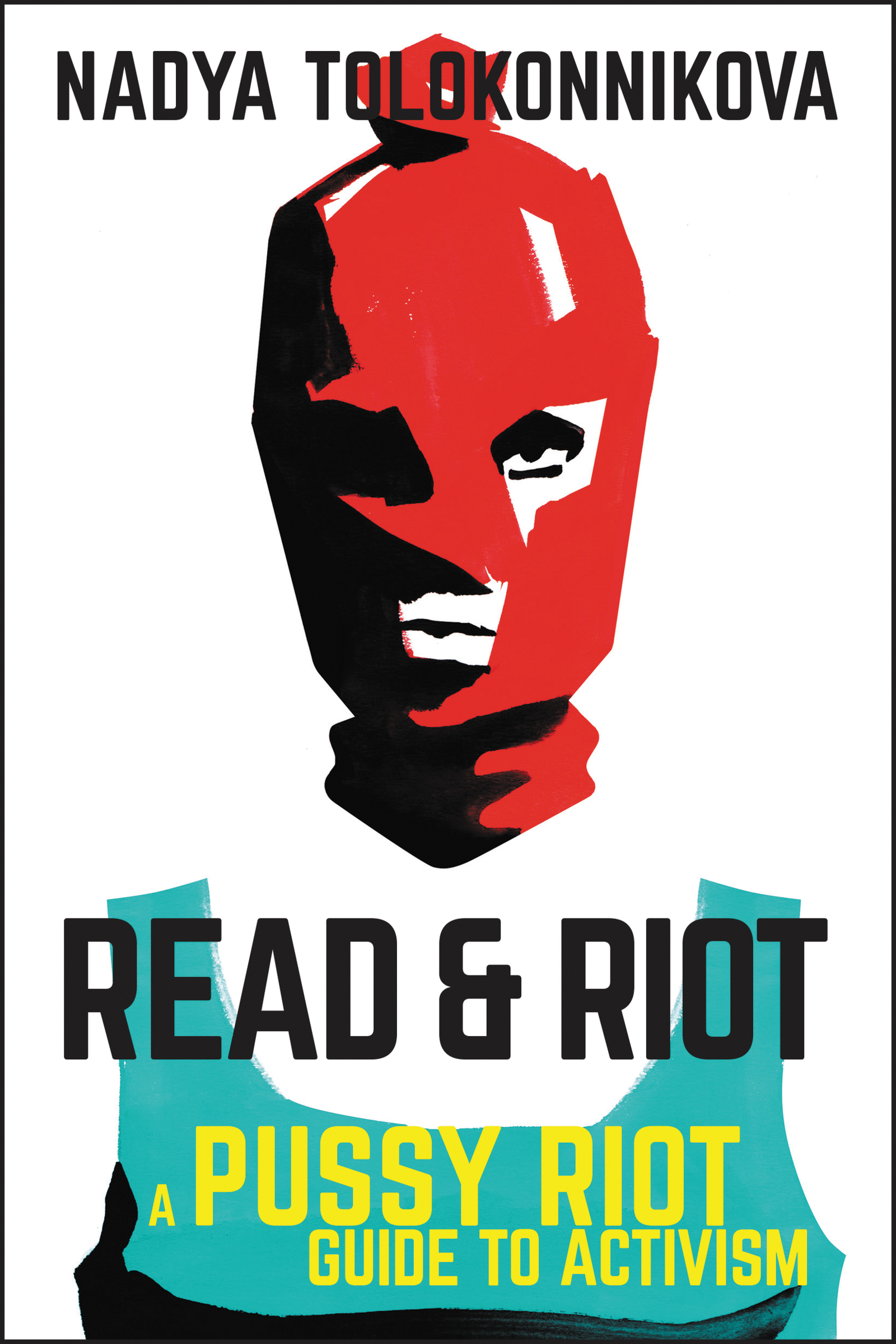
Read & Riot "Stylish, striking, and elegantly packaged...as indispensible to confronting, say, your domineering mother-in-law or your local city council as it is to helping foment an ongoing and ever-escalating insurrection against, say, a sexist, racist, nepotistic power-mad oligarchy threatening to destory democracy as we know it...My advice: Buy one"--VOGUE From artist, activist, and Pussy Riot founder Nadya Tolokonnikova, a guerilla guide to radical protest and joyful political resistance The face of modern protest is wearing a brightly colored ski mask. Nadya Tolokonnikova, founding member of the Russian activist group Pussy Riot, is a creative activist, professional protestor, brazen feminist, shocking visual artist, and force to be reckoned with. Her spontaneous, explosive approach to political action has involved jumping over barbed wire, kissing police officers, giving guerilla performances in crowded subway cars, and going on a hunger strike to protest the abuse of prisoners. She’s been horse-whipped by police in Sochi, temporarily blinded when officers threw green paint in her eyes, and monitored by the Russian government. But what made Nadya an activist icon overnight happened on February 21, 2012, when she was arrested for performing an anti-Putin protest song in a Moscow church. She was sent to a Russian prison for 18 months and emerged as an international symbol of radical resistance, as calls to “Free Pussy Riot†resounded around the world. With her emblematic ski mask, black lipstick, and unwavering bravery, Nadya has become an emissary of hope and optimism despite overwhelming and ugly political corruption. Read & Riot is structured around Nadya’s ten rules for revolution (Be a pirate! Make your government shit its pants! Take back the joy!) and illustrated throughout with stunning examples from her extraordinary life and the philosophies of other revolutionary rebels throughout history. Rooted in action and going beyond the typical “call your senator†guidelines, Read & Riot gives us a refreshing model for civil disobedience, and encourages our right to question every status quo and make political action exciting—even joyful. POLITICAL SCIENCE,Political Freedom

GIS for Homeland Security Government agencies and the private-sector responsible for homeland security must share information to do their jobs effectively. GIS (geographic information systems) helps them accomplish this, whether it’s assessing the risks of a terrorist attack or bracing for a natural disaster. This book tells how programs, mostly regional in nature, have successfully applied GIS to a variety of homeland security challenges. POLITICAL SCIENCE,Political Freedom
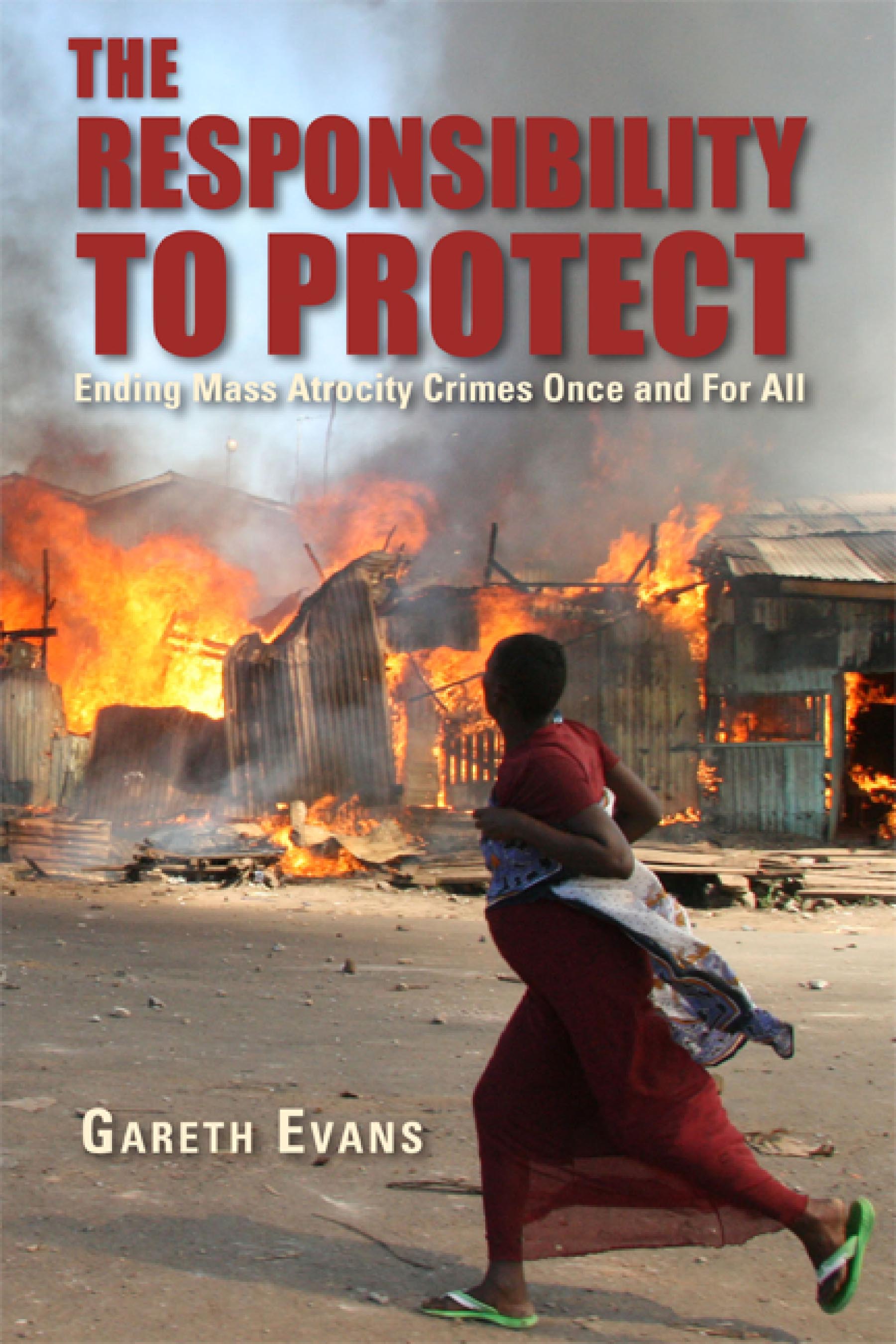
The Responsibility to Protect "Never again!" the world has vowed time and again since the Holocaust. Yet genocide, ethnic cleansing, and other mass atrocity crimes continue to shock our consciencesfrom the killing fields of Cambodia to the machetes of Rwanda to the agony of Darfur. Gareth Evans has grappled with these issues firsthand. As Australian foreign minister, he was a key broker of the United Nations peace plan for Cambodia. As president of the International Crisis Group, he now works on the prevention and resolution of scores of conflicts and crises worldwide. The primary architect of and leading authority on the Responsibility to Protect ("R2P"), he shows here how this new international norm can once and for all prevent a return to the killing fields. The Responsibility to Protect captures a simple and powerful idea. The primary responsibility for protecting its own people from mass atrocity crimes lies with the state itself. State sovereignty implies responsibility, not a license to kill. But when a state is unwilling or unable to halt or avert such crimes, the wider international community then has a collective responsibility to take whatever action is necessary. R2P emphasizes preventive action above all. That includes assistance for states struggling to contain potential crises and for effective rebuilding after a crisis or conflict to tackle its underlying causes. R2P's primary tools are persuasion and support, not military or other coercion. But sometimes it is right to fight: faced with another Rwanda, the world cannot just stand by. R2P was unanimously adopted by the UN General Assembly at the 2005 World Summit. But many misunderstandings persist about its scope and limits. And much remains to be done to solidify political support and to build institutional capacity. Evans shows, compellingly, how big a break R2P represents from the past, and how, with its acceptance in principle and effective application in practice, the promise of "Never POLITICAL SCIENCE,Political Freedom

On Freedom From New York Times bestselling author Cass Sunstein, a brisk, provocative book that shows what freedom really means—and requires—today In this pathbreaking book, New York Times bestselling author Cass Sunstein asks us to rethink freedom. He shows that freedom of choice isn’t nearly enough. To be free, we must also be able to navigate life. People often need something like a GPS device to help them get where they want to go—whether the issue involves health, money, jobs, children, or relationships. In both rich and poor countries, citizens often have no idea how to get to their desired destination. That is why they are unfree. People also face serious problems of self-control, as many of them make decisions today that can make their lives worse tomorrow. And in some cases, we would be just as happy with other choices, whether a different partner, career, or place to live—which raises the difficult question of which outcome best promotes our well-being. Accessible and lively, and drawing on perspectives from the humanities, religion, and the arts, as well as social science and the law, On Freedom explores a crucial dimension of the human condition that philosophers and economists have long missed—and shows what it would take to make freedom real. POLITICAL SCIENCE,Political Freedom
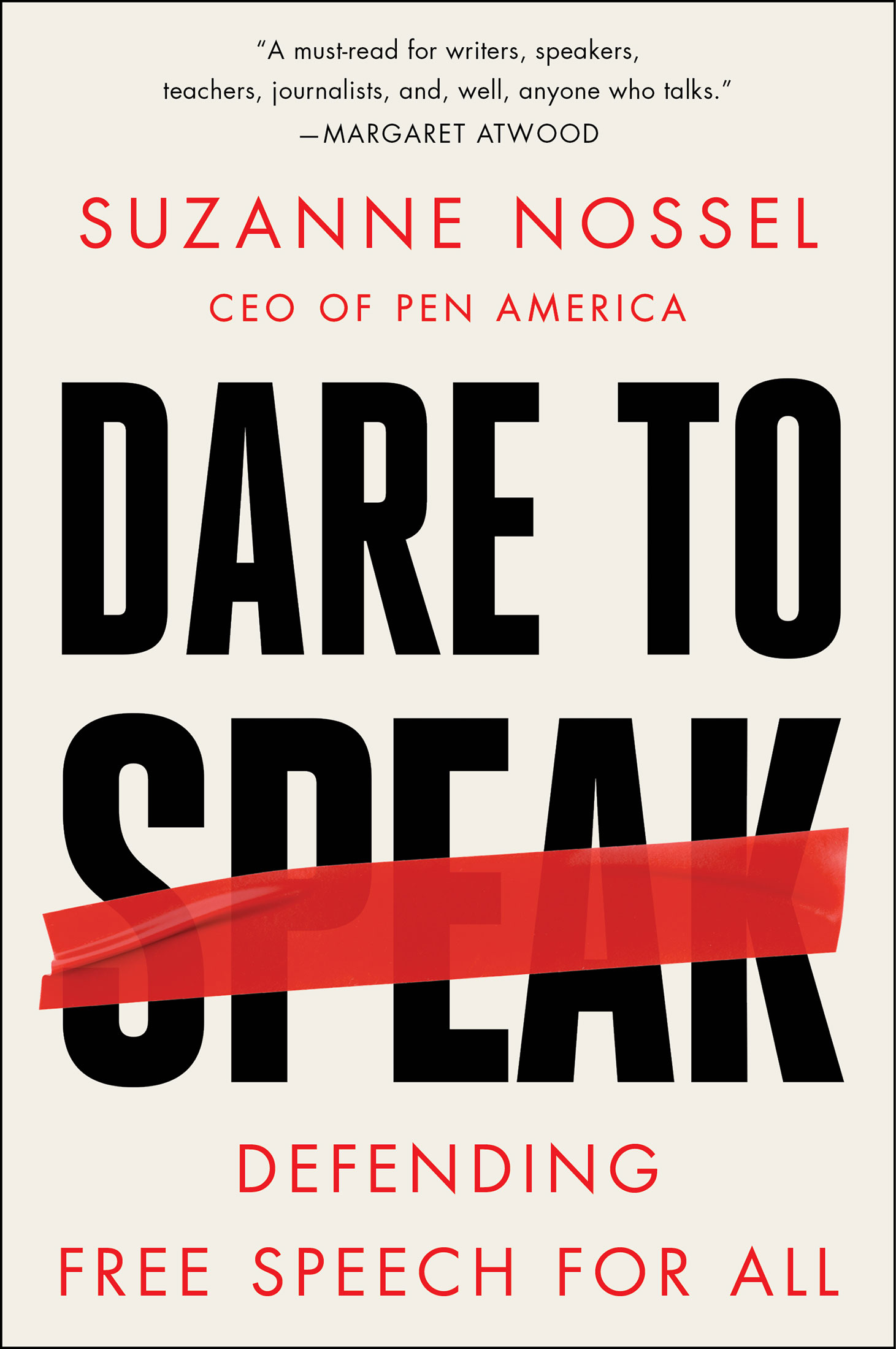
Dare to Speak "A must read."—Margaret Atwood A vital, necessary playbook for navigating and defending free speech today by the CEO of PEN America, Dare To Speak provides a pathway for promoting free expression while also cultivating a more inclusive public culture. Online trolls and fascist chat groups. Controversies over campus lectures. Cancel culture versus censorship. The daily hazards and debates surrounding free speech dominate headlines and fuel social media storms. In an era where one tweet can launch—or end—your career, and where free speech is often invoked as a principle but rarely understood, learning to maneuver the fast-changing, treacherous landscape of public discourse has never been more urgent. In Dare To Speak, Suzanne Nossel, a leading voice in support of free expression, delivers a vital, necessary guide to maintaining democratic debate that is open, free-wheeling but at the same time respectful of the rich diversity of backgrounds and opinions in a changing country. Centered on practical principles, Nossel’s primer equips readers with the tools needed to speak one’s mind in today’s diverse, digitized, and highly-divided society without resorting to curbs on free expression. At a time when free speech is often pitted against other progressive axioms—namely diversity and equality—Dare To Speak presents a clear-eyed argument that the drive to create a more inclusive society need not, and must not, compromise robust protections for free speech. Nossel provides concrete guidance on how to reconcile these two sets of core values within universities, on social media, and in daily life. She advises readers how to: Use language conscientiously without self-censoring ideas; Defend the right to express unpopular views; And protest without silencing speech. Nossel warns against the increasingly fashionable embrace of expanded government and corporate controls over speech, warning that such strictures can reinforce the marginalization of lesser-heard voices. She argues that creating an open market of ideas demands aggressive steps to remedy exclusion and ensure equal participation. Replete with insightful arguments, colorful examples, and salient advice, Dare To Speak brings much-needed clarity and guidance to this pressing—and often misunderstood—debate. POLITICAL SCIENCE,Political Freedom

The Force of Nonviolence “Judith Butler is the most creative and courageous social theorist writing today." – Cornel West “Judith Butler is quite simply one of the most probing, challenging, and influential thinkers of our time.” – J. M. Bernstein Judith Butler’s new book shows how an ethic of nonviolence must be connected to a broader political struggle for social equality. Further, it argues that nonviolence is often misunderstood as a passive practice that emanates from a calm region of the soul, or as an individualist ethical relation to existing forms of power. But, in fact, nonviolence is an ethical position found in the midst of the political field. An aggressive form of nonviolence accepts that hostility is part of our psychic constitution, but values ambivalence as a way of checking the conversion of aggression into violence. One contemporary challenge to a politics of nonviolence points out that there is a difference of opinion on what counts as violence and nonviolence. The distinction between them can be mobilized in the service of ratifying the state’s monopoly on violence. Considering nonviolence as an ethical problem within a political philosophy requires a critique of individualism as well as an understanding of the psychosocial dimensions of violence. Butler draws upon Foucault, Fanon, Freud, and Benjamin to consider how the interdiction against violence fails to include lives regarded as ungrievable. By considering how “racial phantasms” inform justifications of state and administrative violence, Butler tracks how violence is often attributed to those who are most severely exposed to its lethal effects. The struggle for nonviolence is found in movements for social transformation that reframe the grievability of lives in light of social equality and whose ethical claims follow from an insight into the interdependency of life as the basis of social and political equality. POLITICAL SCIENCE,Political Freedom
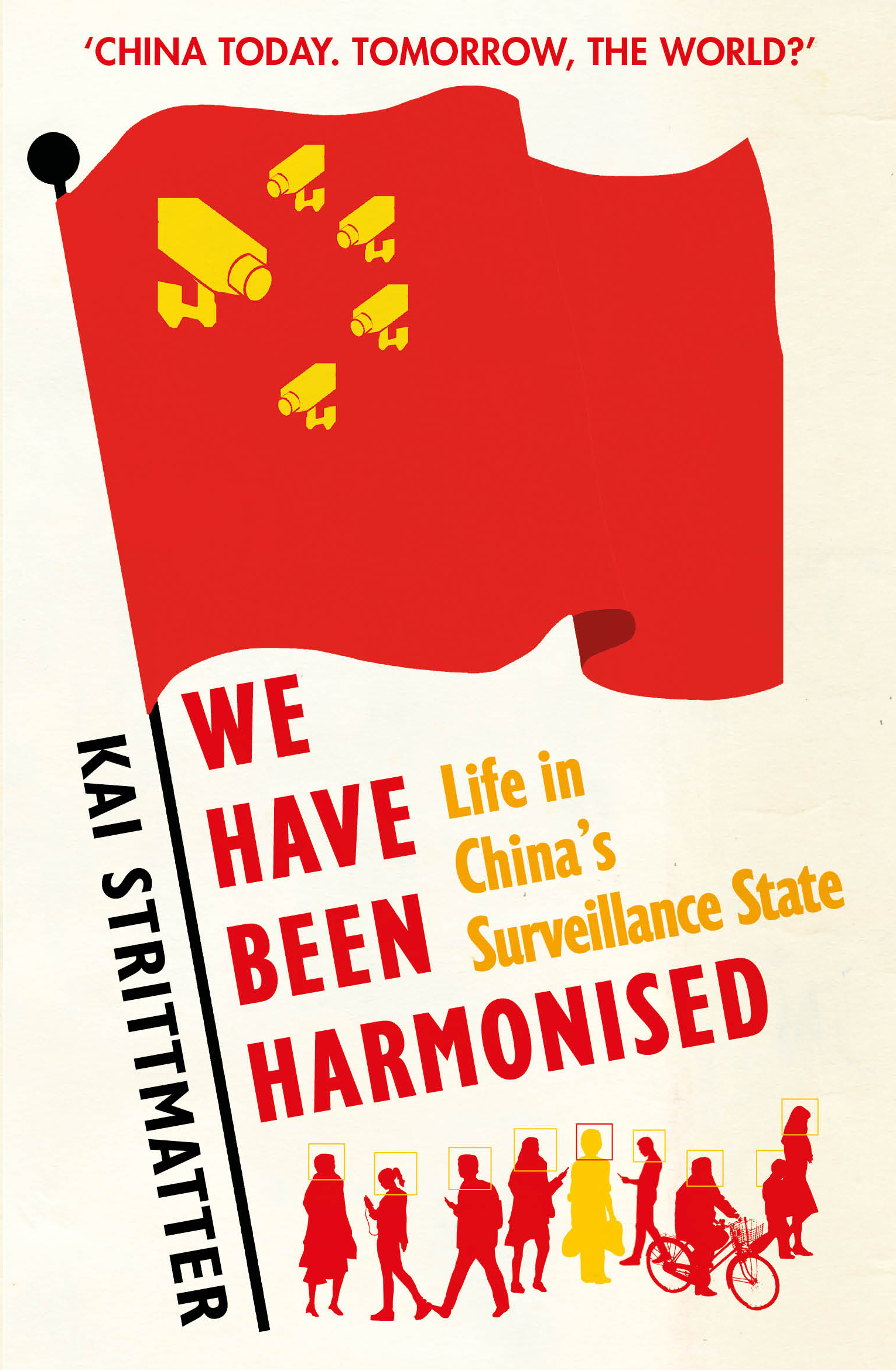
We have been harmonised CHINA TODAY. TOMORROW, THE WORLD? In China's shiny new 'Smart Cities', citizens can scarcely cross the road or buy an orange without the Party knowing, and posting a satirical online comment about President Xi's Winnie-the-Pooh-like features can land you in jail.A generation after the tanks rolled into Tiananmen Square, China's autocratic leaders are using powerful new technologies to create the largest and most effective surveillance state the world has ever seen. This is a journey into a land where Big Brother has acquired a whole new set of toys with which to control and cajole -- 'harmonise' -- the masses. It is also a warning against Western complacency. Beijing is already finding eager buyers for its 'Operating System for Dictators' -- in Africa and Asia, Russia and the Middle East. And with China's corporate giants -- all ultimately under Party control -- being offered a place at the heart of Europe's vital infrastructure, it is time we paid attention. POLITICAL SCIENCE,Political Freedom
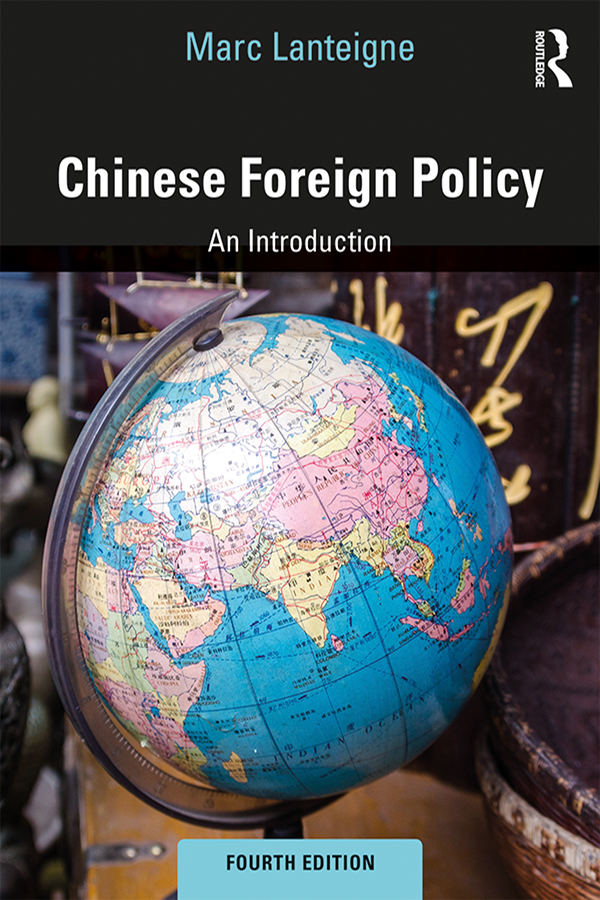
Chinese Foreign Policy This updated and expanded fourth edition of Chinese Foreign Policy seeks to examine the decision-makers, processes, and rationales behind China’s expanding international relations as well as offering an in-depth look at China’s modern global relations. Among the key issues explored in this edition are: The further expansion of Chinese foreign policy from regional (Asia-Pacific) to international interests; How the government of Xi Jinping has pursued a more confident great power foreign policy agenda; China’s growing economic power in an era of global financial uncertainty and the return of protectionism; Modern security challenges, including counter-terrorism, cyber-security, maritime power, military reform and modernisation, and the protection of overseas economic interests; China’s shifting power relationship with the United States under President Donald Trump; The deeper engagement of Beijing with a growing number of international and regional institutions and legal affairs; Cross-regional diplomacy, including updated sections on Africa, Latin America, the Middle East, and Russia / Eurasia, as well as Oceania and the Polar regions; The development of the Belt and Road Initiative (BRI) as a centrepiece of China’s foreign policy. This book will be essential reading for students of Chinese foreign policy and Asian international relations (IR), and is highly recommended for students of diplomacy, international security, and IR in general. POLITICAL SCIENCE,Political Freedom

Fair Play Revolutionary War officer Nathan Hale, one of America’s first spies, said, “Any kind of service necessary to the public good becomes honorable by being necessary.” A statue of Hale stands outside CIA headquarters, and the agency often cites his statement as one of its guiding principles. But who decides what is necessary for the public good, and is it really true that any kind of service is permissible for the public good? These questions are at the heart of James M. Olson’s book, Fair Play: The Moral Dilemmas of Spying . Olson, a veteran of the CIA’s clandestine service, takes readers inside the real world of intelligence to describe the difficult dilemmas that field officers face on an almost daily basis. Far from being a dry theoretical treatise, this fascinating book uses actual intelligence operations to illustrate how murky their moral choices can be. Readers will be surprised to learn that the CIA provides very little guidance on what is, or is not, permissible. Rather than empowering field officers, the author has found that this lack of guidelines actually hampers operations. Olson believes that U.S. intelligence officers need clearer moral guidelines to make correct, quick decisions. Significantly, he believes these guidelines should come from the American public, not from closed-door meetings inside the intelligence community. Fair Play will encourage a broad public debate about the proper moral limits on U.S. intelligence activities. POLITICAL SCIENCE,Political Freedom
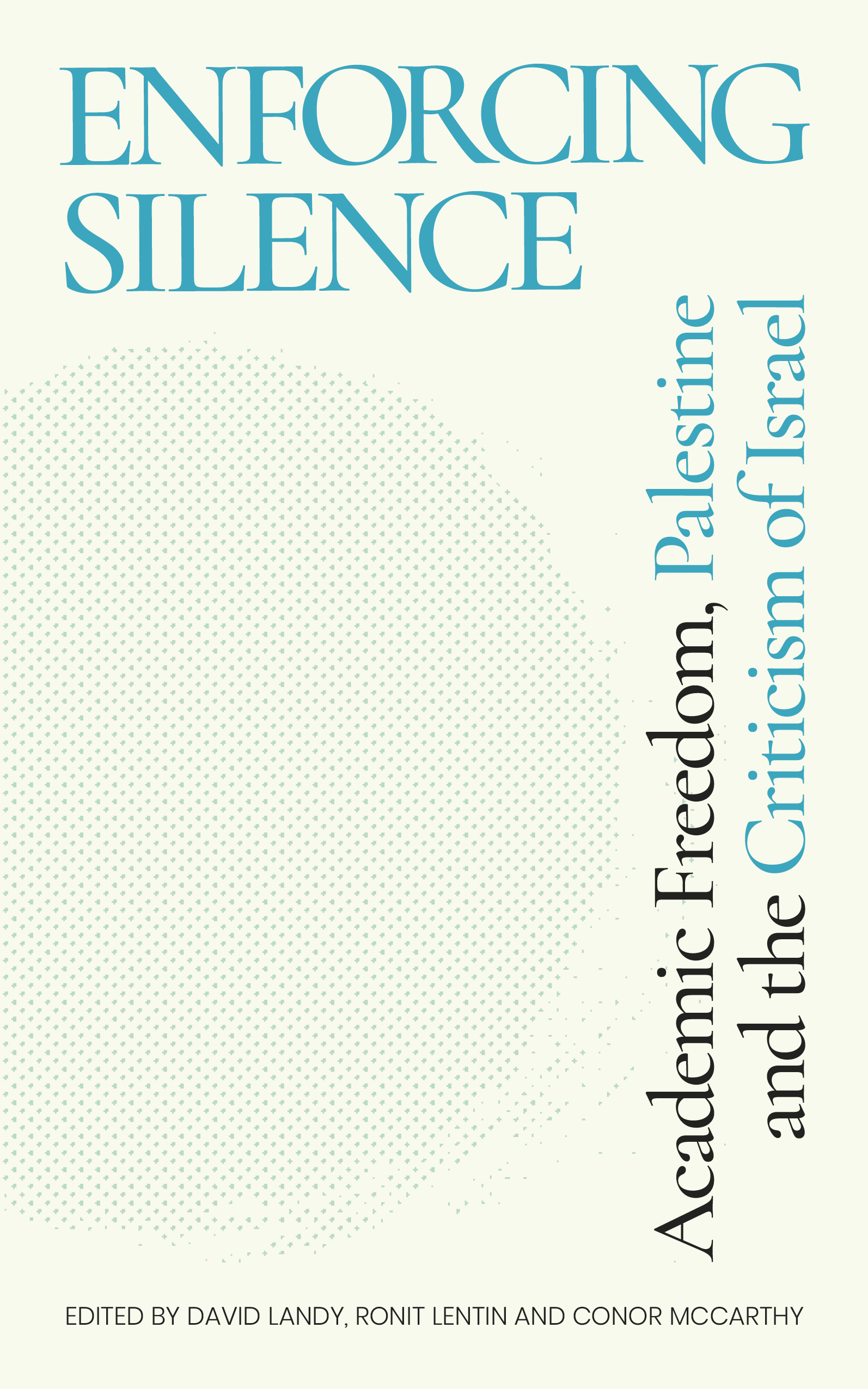
Enforcing Silence Situates the academic boycott of Israel in the broader context of academic freedom POLITICAL SCIENCE,Political Freedom

Live Not by Lies The New York Times bestselling author of The Benedict Option draws on the wisdom of Christian survivors of Soviet persecution to warn American Christians of approaching dangers. For years, émigrés from the former Soviet bloc have been telling Rod Dreher they see telltale signs of "soft" totalitarianism cropping up in America--something more Brave New World than Nineteen Eighty-Four. Identity politics are beginning to encroach on every aspect of life. Civil liberties are increasingly seen as a threat to "safety". Progressives marginalize conservative, traditional Christians, and other dissenters. Technology and consumerism hasten the possibility of a corporate surveillance state. And the pandemic, having put millions out of work, leaves our country especially vulnerable to demagogic manipulation. In Live Not By Lies, Dreher amplifies the alarm sounded by the brave men and women who fought totalitarianism. He explains how the totalitarianism facing us today is based less on overt violence and more on psychological manipulation. He tells the stories of modern-day dissidents--clergy, laity, martyrs, and confessors from the Soviet Union and the captive nations of Europe--who offer practical advice for how to identify and resist totalitarianism in our time. Following the model offered by a prophetic World War II-era pastor who prepared believers in his Eastern European to endure the coming of communism, Live Not By Lies teaches American Christians a method for resistance: • SEE: Acknowledge the reality of the situation. • JUDGE: Assess reality in the light of what we as Christians know to be true. • ACT: Take action to protect truth. Aleksandr Solzhenitsyn famously said that one of the biggest mistakes people make is assuming totalitarianism can't happen in their country. Many American Christians are making that mistake today, sleepwalking through the erosion of our freedoms. Live Not By Lies will wake them and equip them for the long resistance. POLITICAL SCIENCE,Political Freedom

Encyclopedia Of Indian Freedom Fighters Jawaharlal Nehru Pandit Jawaharlal Nehru (November 14,1889-May 27, 1964) was a major political leader of the Congress Party, a pivotal figure in the Indian independence movement and the first Prime Minister of independent India. Nehru's greatest contribution to India in the importance that he had given to science, technology and industrialisation without which progress was impossible. He was fighting alongside the main currents of socio-cultural life in the country. He was opposed to traditions and superstitions. India had controversially opposed the partition of Palestine and the 1956 invasion of the Sinai by Israel, Britain and France, but did not oppose the Chinese occupation of Tibet and the suppression of a pro-democracy movement in Hungary by the Soviet Union. Although Nehru disavowed nuclear ambitions for India, Canada and France aided India in the development of nuclear power stations for electricity. India also negotiated an agreement in 1960 with Pakistan on the just use of the waters of seven rivers shared by the countries. POLITICAL SCIENCE,Political Freedom

Encyclopedia Of Indian Freedom Fighters Sardar Vallabh Bhai Patel Sardar Vallabhbhai Patel (31 October 1875 - 15 December 1950) was a political and social leader of India who played a major role in the country's struggle for independence and guided its integration into a united, independent nation. In India and across the world, he was often addressed as Sardar which means Chief in many languages of India. Vallabhbhai Patel, the 'Iron Man of India', was born in Nandiad, Gujarat, to Ladbai and Jhaverbhai Patel. He was one of their six children, five boys and a girl. There is no record of his date of birth. The generally accepted date, 31 October 1875, is taken from his matriculation certificate. It was an agriculturist family in which Vallabh was born and not a well-to-do one. His childhood was spent working on the family's ten acre farm at Karamsad, just like any other farmer's son, away from books. His education was thus erratic, though he was sent to the middle school at Karamsad from where he passed in his late teens. To continue his education, he joined the High School at Nandiad and passed the matriculation examination in 1897 at the age of twenty-two. In the meanwhile, he was married at the age of sixteen to Javerbai, a girl from a nearby village. Javerbai died in 1909 when Vallabhbhai was thirty three but he did not remarry. The couple had two children, a son, Dhayabhai and daughter, Manibehn. POLITICAL SCIENCE,Political Freedom

Encyclopedia Of Indian Freedom Fighters Subhash Chandra Bose Bose was elected president of the Indian National Congress for two consecutive terms but resigned from the post following ideological conflicts with Mahatma Gandhi. Bose believed that Mahatma Gandhi's tactics of nonviolence would never be sufficient to secure India's independence, and advocated violent resistance. He established a separate political party, the All India Forward Bloc and continued to call for the full and immediate independence of India from British rule. He was imprisoned by the British authorities eleven times. His stance did not change with the outbreak of the Second World War, which he saw as an opportunity to take advantage of British weakness. POLITICAL SCIENCE,Political Freedom
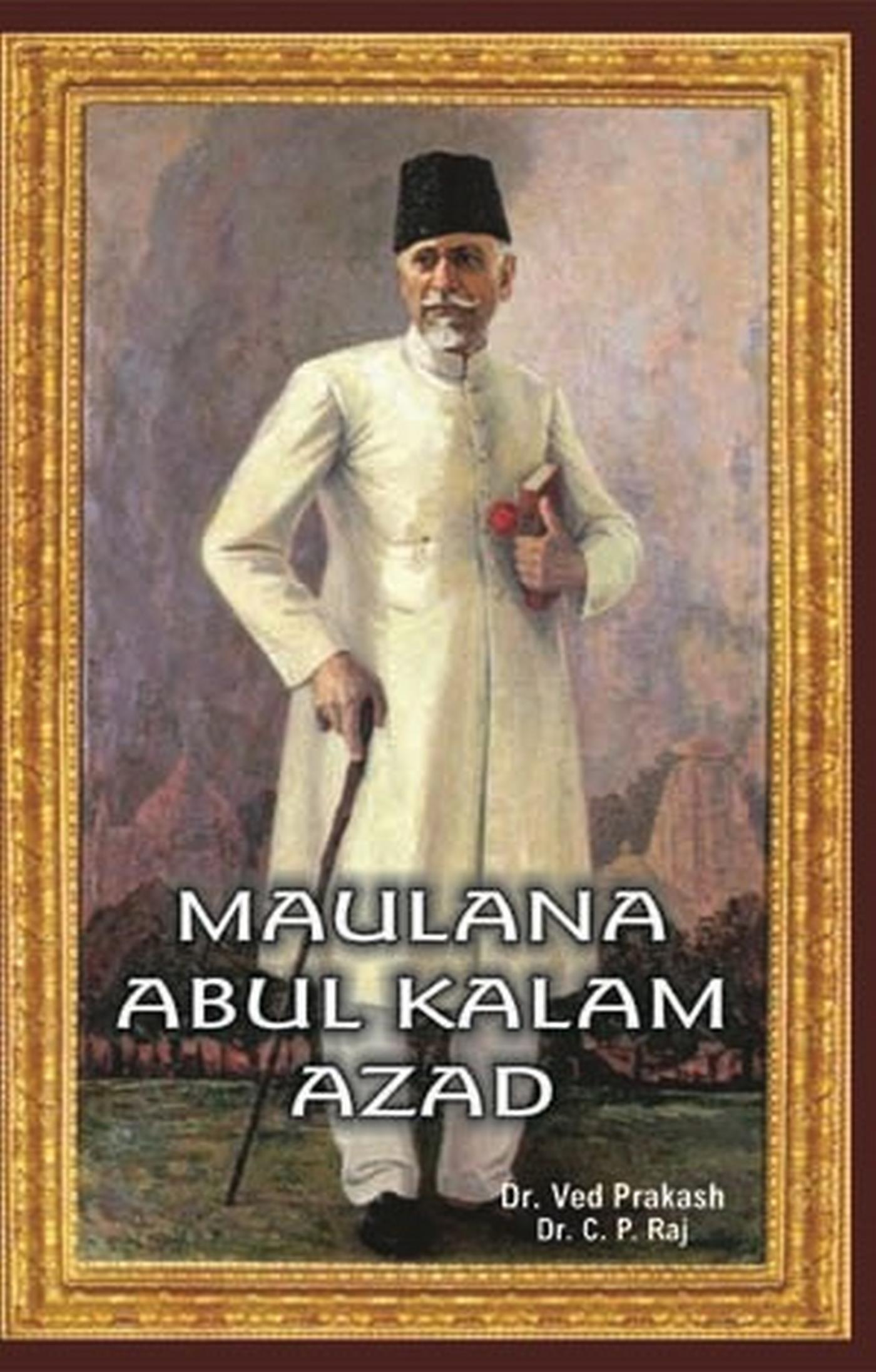
Encyclopedia Of Indian Freedom Fighters Maulana Abul Kalam Azad On February 22, 1958 Maulana Abul Kalam Azad, one of the foremost leaders of the Indian freedom struggle passed away. For his invaluable contribution to the nation, Maulana Abul Kalam Azad was posthumously awarded India's highest civilian honor, the zBharat Ratna' in 1992. Journalist, Scholar, author, freedom fighter, and the first minister for education in the first ministry of independent India, Abul Kalam Mohiyuddin Ahmed was born in Mecca in 1888. His father was Maulana Muhamed Khairuddin, a great Islamic scholar. He migrated to Mecca after the First Independence Struggle of India of 1857. He came into the attention of Muhamed Zahir Vatri, a renowned scholar of Medina and married his daughter Aeli. They had five kids, including Abul Kalam. The sudden demise of his wife made Sheikh Khairuddin decide to return to India and he settled in Calcutta with his kids. POLITICAL SCIENCE,Political Freedom
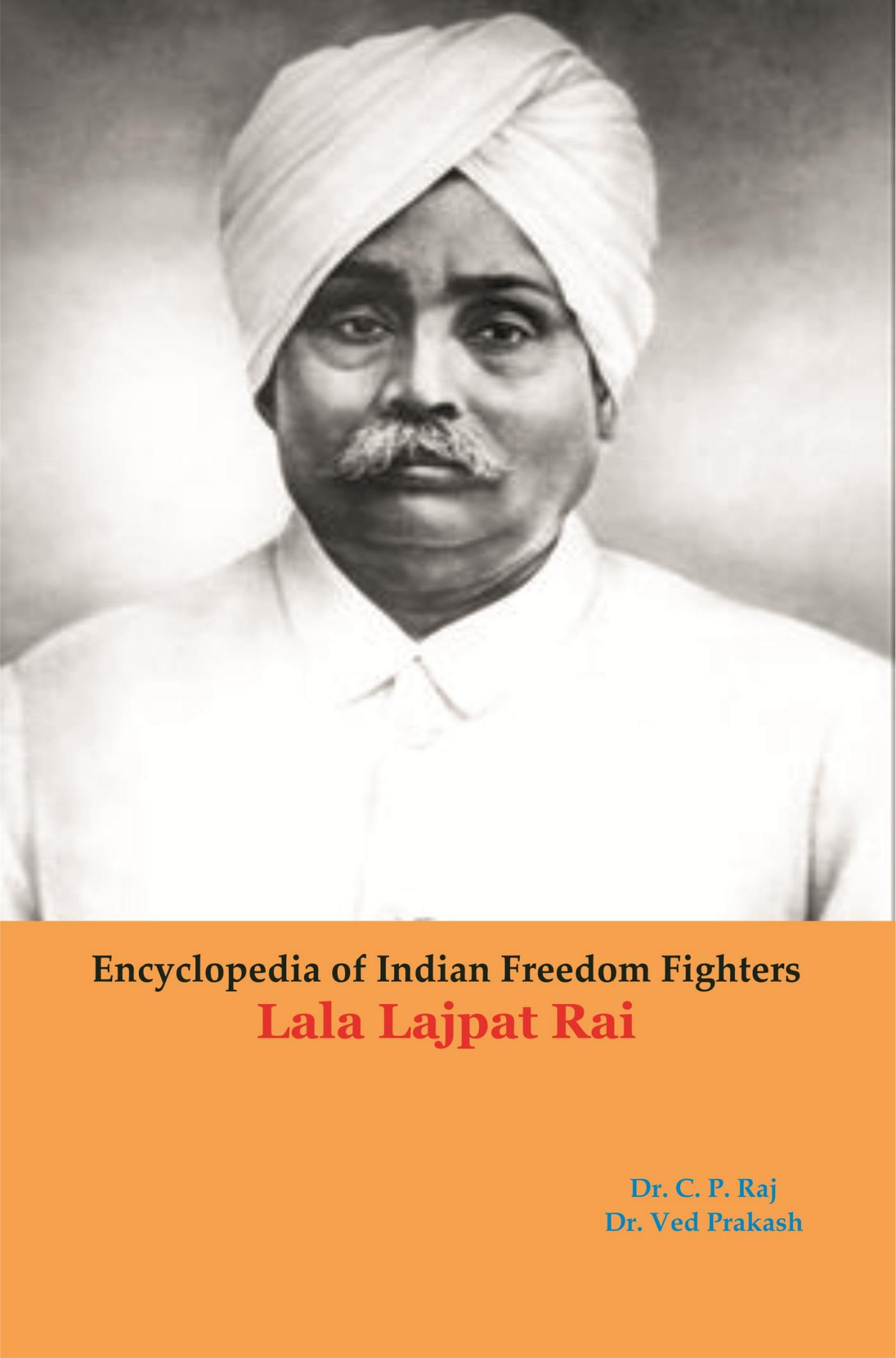
Encyclopedia Of Indian Freedom Fighters Lala Lajpat Rai Lala Lajpat Rai (1865-1928) was an Indian author and politician who is chiefly remembered as a leader in the Indian fight for freedom from the British Raj. He was popularly known as Punjab Kesari (The Caesar of Punjab). He was also the founder of Punjab National Bank and Lakshmi Insurance Company. The non-cooperation movement failed. Therefore there was a lull in political activities. In 1927 the British Government wanted a report on political reforms in India and on amending the Government of India Act. So it appointed a commission. The commission consisted of Sir John Simon and six other members. All of them were members of the British Parliament. There was not a single Indian as member. It was composed solely of White people. The commission was an insult to Indians. These White men were to shape the future of India. The people of India rose as one man against this step. Under Lalaji's leadership, it was resolved to boycott the Simon Commission. POLITICAL SCIENCE,Political Freedom

Encyclopedia Of Indian Freedom Fighters Dr. Bhim Rao Ambedkar Bhimrao Ramji Ambedkar (14 April 1891 - 6 December 1956), also known as Babasaheb, was an Indian jurist, political leader, Buddhist activist, philosopher, thinker, anthropologist, historian, orator, prolific writer, economist, scholar, editor, revolutionary and a revivalist for Buddhism in India. He was also the chief architect of the Indian Constitution. Born into a poor Mahar, then Untouchable, family, Ambedkar spent his whole life fighting against social discrimination, the system of Chaturvarna - the categorization of Hindu society into four varnas - and the Hindu caste system. He is also credited with providing a spark for the conversion of hundreds of thousands of Dalits with his Ambedkar (ite) Buddhism. Ambedkar has been honoured with the Bharat Ratna, India's highest civilian award. POLITICAL SCIENCE,Political Freedom

Encyclopedia of Indian Freedom Fighters Lal Bahadur Shastri Shri Lal Bahadur Shastri was born on October 2, 1901 at Mughalsarai, a small railway town seven miles from Varanasi in Uttar Pradesh. His father was a school teacher who died when Lal Bahadur Shastri was only a year and half old. His mother, still in her twenties, took her three children to her father's house and settled down there. As he grew up, Lal Bahadur Shastri became more and more interested in the country's struggle for freedom from foreign yoke. He was greatly impressed by Mahatma Gandhi's denunciation of Indian Princes for their support of British rule in India. Lal Bahadur Sashtri was only eleven at the time, but the process that was end day to catapult him to the national stage had already begun in his mind. Lal Bahadur Shastri joined the Kashi Vidya Peeth in Varanasi, one of the many national institutions set up in defiance of the British rule. There, he came under the influence of the greatest intellectuals, and nationalists of the country. 'Shastri' was the bachelor's degree awarded to him by the Vidya Peeth but has stuck in the minds of the people as part of his name. POLITICAL SCIENCE,Political Freedom
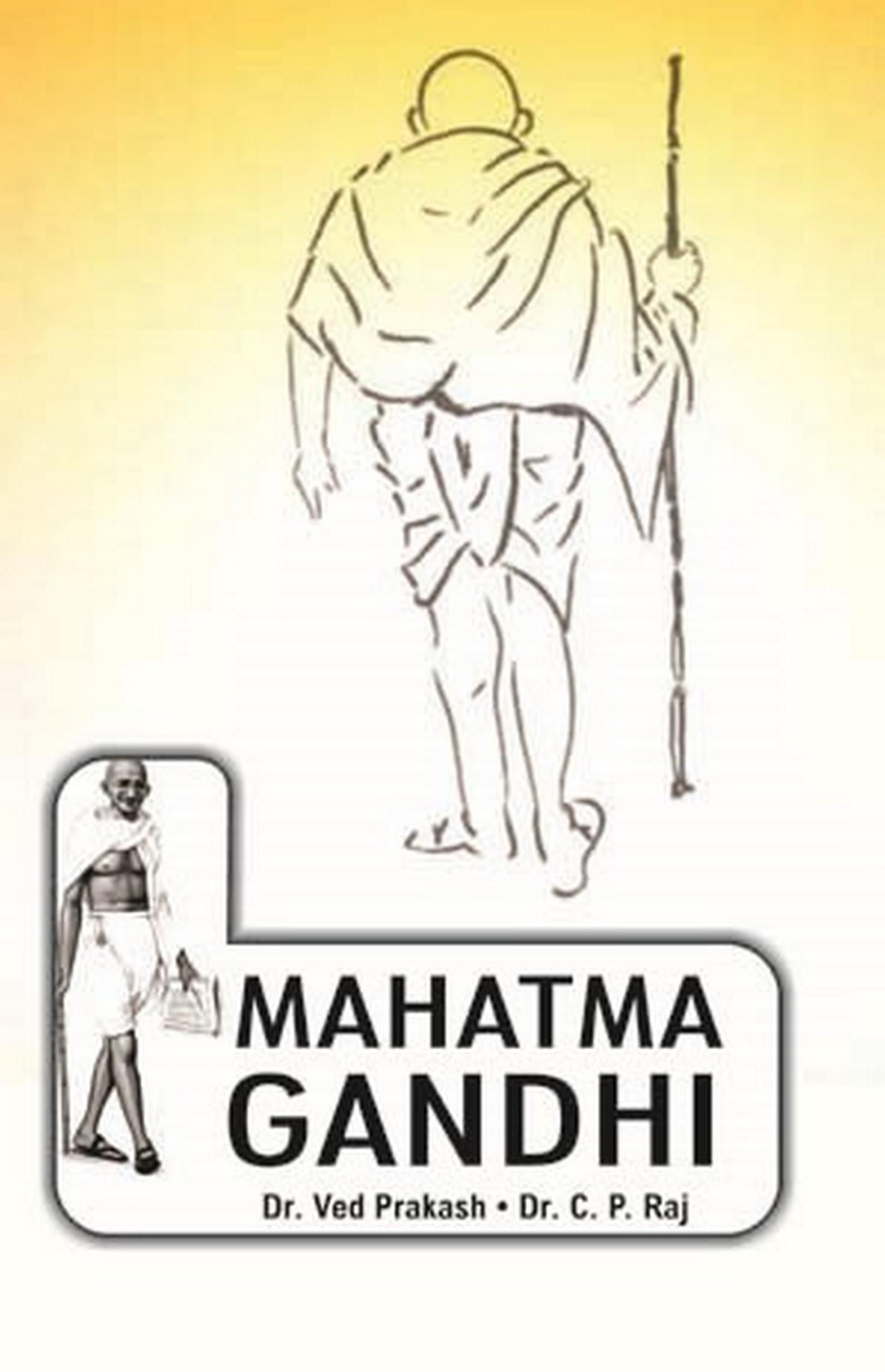
Encyclopedia Of Indian Freedom Fighters Mahatma Gandhi Gandhi was born on October 2, 1869, at Porbandar. Mohandas or Mohan was youngest of the three sons of Putlibai and Karamchand Gandhi. In January 1948, before three pistol shots put an end to his life, Gandhi had been on the political stage for more than fifty years. He had inspired two generations of India, patriots, shaken an empire and sparked off a revolution which was to change the face of Africa and Asia. To millions of his own people, he was the Mahatma-the great soul-whose sacred glimpse was a reward in itself. By the end of 1947 he had lived down much of the suspicion, ridicule and opposition which he had to face, when he first raised the banner of revolt against racial exclusiveness and imperial domination. His ideas, once dismissed as quaint and utopian, had begun to strike answering chords in some of the finest minds in the world. "Generations to come, it may be", Einstein had said of Gandhi in July 1944, "will scarcely believe that such one as this ever in flesh and blood walked upon earth." POLITICAL SCIENCE,Political Freedom

Encyclopedia Of Indian Freedom Fighters Shaheed Bhagat Singh Bhagat Singh is considered to be one of the most influential revolutionaries of Indian Nationalist Movement. He became involved with numerous revolutionary organizations and played an important role in the Indian National movement. He died a martyr at the age of just 23 years. Following his execution, on March 23, 1931, the supporters and followers of Bhagat Singh regarded him as a "Shaheed†The legend of Bhagat Singh, a valiant fighter of freedom, will continue to inspire the youth of our country forever. His spirit of self-sacrifice and the fearless manner in which he faced death are unparalleled in the annals of the freedom struggle of India. POLITICAL SCIENCE,Political Freedom

Encyclopedia Of Indian Freedom Fighters Bal Gangadhar Tilak Bal Gangadher Tila (July 23, 1856-August 1, 1920), was an Indian National, Social Reformer and freedom Fighter who was the first popular leader of the Indian Independence Movement and is known as "Father of the Indian Unrest." Tilak was one of the first and strongest proponents for Swaraj (complete independence) in Indian consciousness, and is considered the father of Hindu Nationalism as well. His famous quote, "Swaraj is my birth right, and I shall have it!" is well-remembered in India even today. Reverently Addressed as Lokmanya ( meaning "Beloved of the people" or "Revered by the world") Tilak was scholar of Indian History, Sanskrit, Hindusim, mathematics, law and astronomy. Tilak was so disappointed by the brutal incident of Jalianwala Bagh massacre that his health started declining. Despite his illness, Tilak issued a call to the Indians not to stop the movement no matter what happened. He was raring to lead the movement but his health did not permit Tilak suffered from diabetes and had become very weak by this time. I mid-July 1920, his condition worsened and on August I, he passed away. All the matter is just compiled and edited in nature. Tilak from the various sources which are in public domain. After Tilak,s death on August 1, 1920 on the first day of Gandhi's first non-cooperation campaign, Gandhi paid his respects at his cremation in Mumbai, along with 20,000,000 people. Gandhi called Tilak "The make of modern India". The court which convicted Tilak bears a plaque that sys, "The action of Tilak has been justified as the right of every individual to fight for his country. POLITICAL SCIENCE,Political Freedom
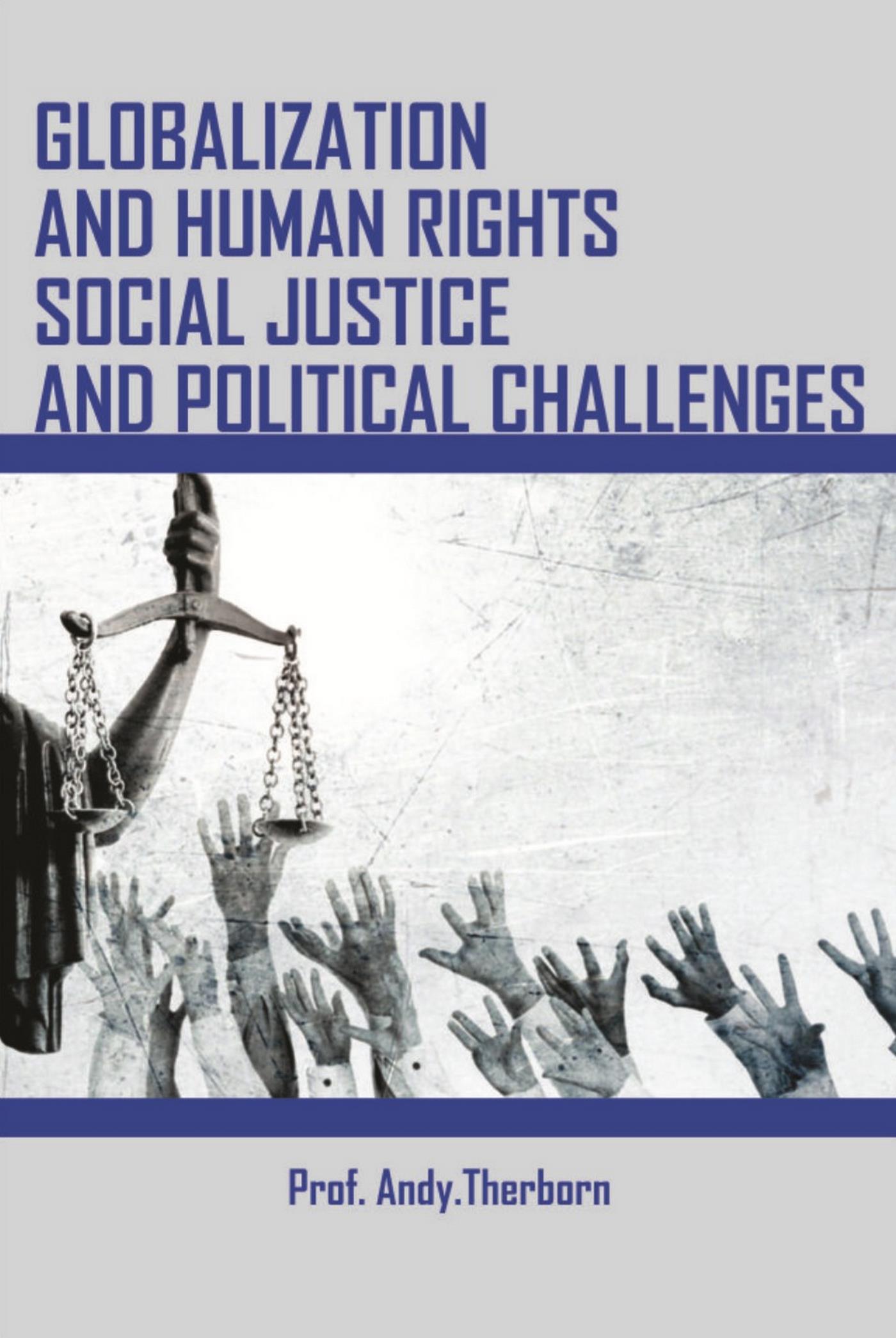
Globalization And Human Rights, Social Justice And Political Challenges Globalization (or globalisation) describes a process by which regional economies, societies, and cultures have become integrated through a globe-spanning network of communication and trade. The term is sometimes used to refer specifically to economic globalization: the integration of national economies into the international economy through trade, foreign direct investment, capital flows, migration, and the spread of technology. Human rights are thus conceived in a universalist and egalitarian fashion. Such entitlements can exist as shared norms of actual human moralities, as justified moral norms or natural rights supported by strong reasons, or as legal rights either at a national level or within international law. However, there is no consensus as to precise nature of what in particular should or should not be regarded as a human right in any of the preceding senses, and the abstract concept of human rights has been a subject of intense philosophical debate and criticism. The ideology of human rights is one of the most powerful forces today largely at the level of rhetoric, but also as justification for action, particularly the collective interventions by the international community in oppressive states. The ideology of rights and the acceptance that the international community has the overriding responsibility for their protection has been invoked to justify limits on state sovereignty, a cornerstone of the international system. This book, which we hope will lay the foundations for the next generation of this subject. POLITICAL SCIENCE,Political Freedom
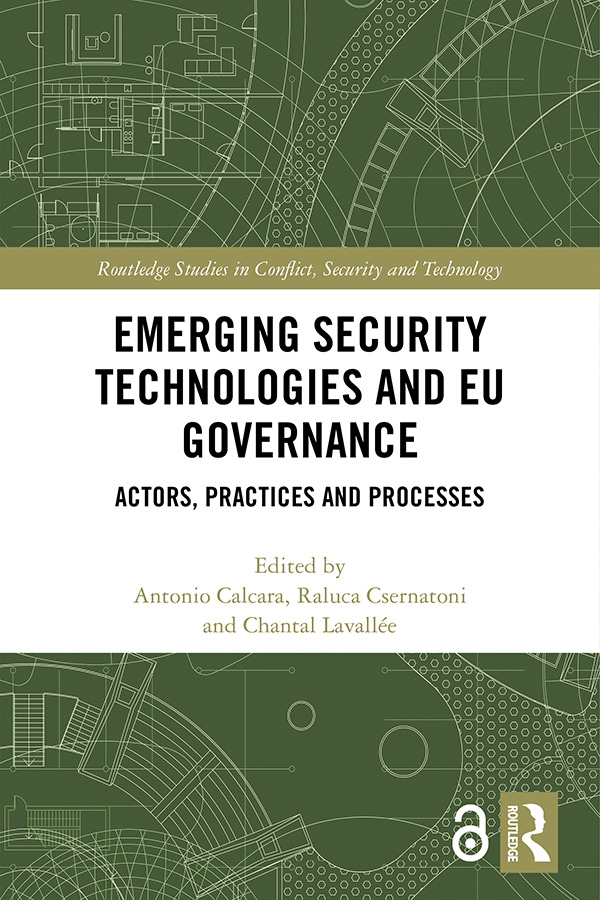
Emerging Security Technologies and EU Governance This book examines the European governance of emerging security technologies. The emergence of technologies such as drones, autonomous robotics, artificial intelligence, cyber and biotechnologies has stimulated worldwide debates on their use, risks and benefits in both the civilian and the security-related fields. This volume examines the concept of ‘governance’ as an analytical framework and tool to investigate how new and emerging security technologies are governed in practice within the European Union (EU), emphasising the relational configurations among different state and non-state actors. With reference to European governance, it addresses the complex interplay of power relations, interests and framings surrounding the development of policies and strategies for the use of new security technologies. The work examines varied conceptual tools to shed light on the way diverse technologies are embedded in EU policy frameworks. Each contribution identifies actors involved in the governance of a specific technology sector, their multilevel institutional and corporate configurations, and the conflicting forces, values, ethical and legal concerns, as well as security imperatives and economic interests. This book will be of much interest to students of science and technology studies, security studies and EU policy. Chapter 11 of this book is freely available as a downloadable Open Access PDF under a Creative Commons Attribution-Non Commercial-No Derivatives 4.0 license https://www.routledge.com/Emerging-Security-Technologies-and-EU-Governance-Actors-Practices-and/Calcara-Csernatoni-Lavallee/p/book/9780367368814 POLITICAL SCIENCE,Political Freedom

Not Free America Not Free America is a call to all Americans to take back our constitutional freedoms and break free of “our abusive relationship with our government.†Mike Donovan’s groundbreaking work on behalf of personal liberties has made him an object of fascination on both the Right and the Left. In this groundbreaking book, Mike Donovan, the CEO of Nexus Services, calls out the elites who wield power in our country—not only the elites at the federal level, but the elites who exert control over us in our states and counties, our cities and towns. Not Free America is a passionate call to all freedom-loving Americans to take back our constitutional freedoms and break free of what he calls “our abusive relationship with our government.†Donovan details how the “wholesale shredding of the Bill of Rights†started long before the concurrent crises of Covid-19 and the protests and violence that followed the murder of George Floyd. Not Free America shows us how those events were used by forces in our local, state, and federal governments that had systematically been abridging our rights for decades. These rights, Mike reminds us, are God-given rights guaranteed to us by the Constitution, the Bill of Rights and the Fourteenth Amendment. As the pastor of the First Christian Church Universalist in Harrisonburg, Virginia, Mike Donovan is far from your quiet country clergyman. A fierce warrior with the spirit of God and the tough skin of a lawyer, he has dedicated his life to protecting liberty and preserving individual rights, serving the underserved, and ministering to those who are overlooked in our broken society. Indeed, there are aspects to his past and present that make him an easy target for judgment from all directions. But Mike Donovan hides from nothing: He openly embraces the faults of his past and dedicates his present to creating a future that helps others move past their own unfortunate pasts. Born to a poor family in Page County, Virginia, he found himself at a young age convicted of writing bad checks, resulting in multiple felonies for which he served seven months in the county jail. But the time he served didn’t break him; it helped make him the man he is today: a man of the law and a man of God who believes with all his heart and soul in the possibility of redemption and the power of moving beyond past mistakes. He also came out of that experience knowing he needed to make a difference for others who found themselves in the same place he’d just been. Not content to talk the talk, Mike Donovan walks the walk in the footsteps of the Jesus who said “I was in prison and you came to visit me . . . Whatever you do for the least of these, you do for me.†Not Free America shows us how to do all that for America and for our children. The book ends with “The Liberty Pledgeâ€: an agreement readers will make stating that they will vote only for lawmakers who agree to uphold the rights and freedoms guaranteed by the Bill of Rights and the Fourteenth Amendment. POLITICAL SCIENCE,Political Freedom

Necessary Secrets An intensely controversial scrutiny of American democracy’s fundamental tension between the competing imperatives of security and openness. “Leakingâ€â€”the unauthorized disclosure to the press of secret information—is a well-established part of the U.S. government’s normal functioning. Gabriel Schoenfeld examines history and legal precedent to argue that leaks of highly classified national-security secrets have reached hitherto unthinkable extremes, with dangerous potential for post-9/11 America. He starts with the New York Times’ recent decision to reveal the existence of top-secret counterterrorism programs, tipping off al Qaeda operatives to the intelligence methods designed to apprehend them. He then steps back to the Founding Fathers' intense preoccupation with secrecy in the conduct of foreign policy. Shifting to the 20th century, he scrutinizes some of the more extraordinary leaks and their consequences, from the public disclosure of the vulnerability of Japanese diplomatic codes in the years before Pearl Harbor to the publication of the Pentagon Papers in the Nixon era to the systematic exposure of undercover CIA agents by the renegade CIA agent Philip Agee. Returning to our present dilemmas, Schoenfeld discovers a growing rift between a press that sees itself as the heroic force promoting the public’s “right to know†and a government that needs to safeguard information vital to the effective conduct of national defense. Schoenfeld places the tension between openness and security in the context of a broader debate about freedom of the press and its limits. With the United States still at war, Necessary Secrets is of burning contemporary interest. But it is much more than a book of the moment. Grappling with one of the most perplexing conundrums of our democratic order, it offers a masterful contribution to the enduring challenge of interpreting the First Amendment. POLITICAL SCIENCE,Political Freedom
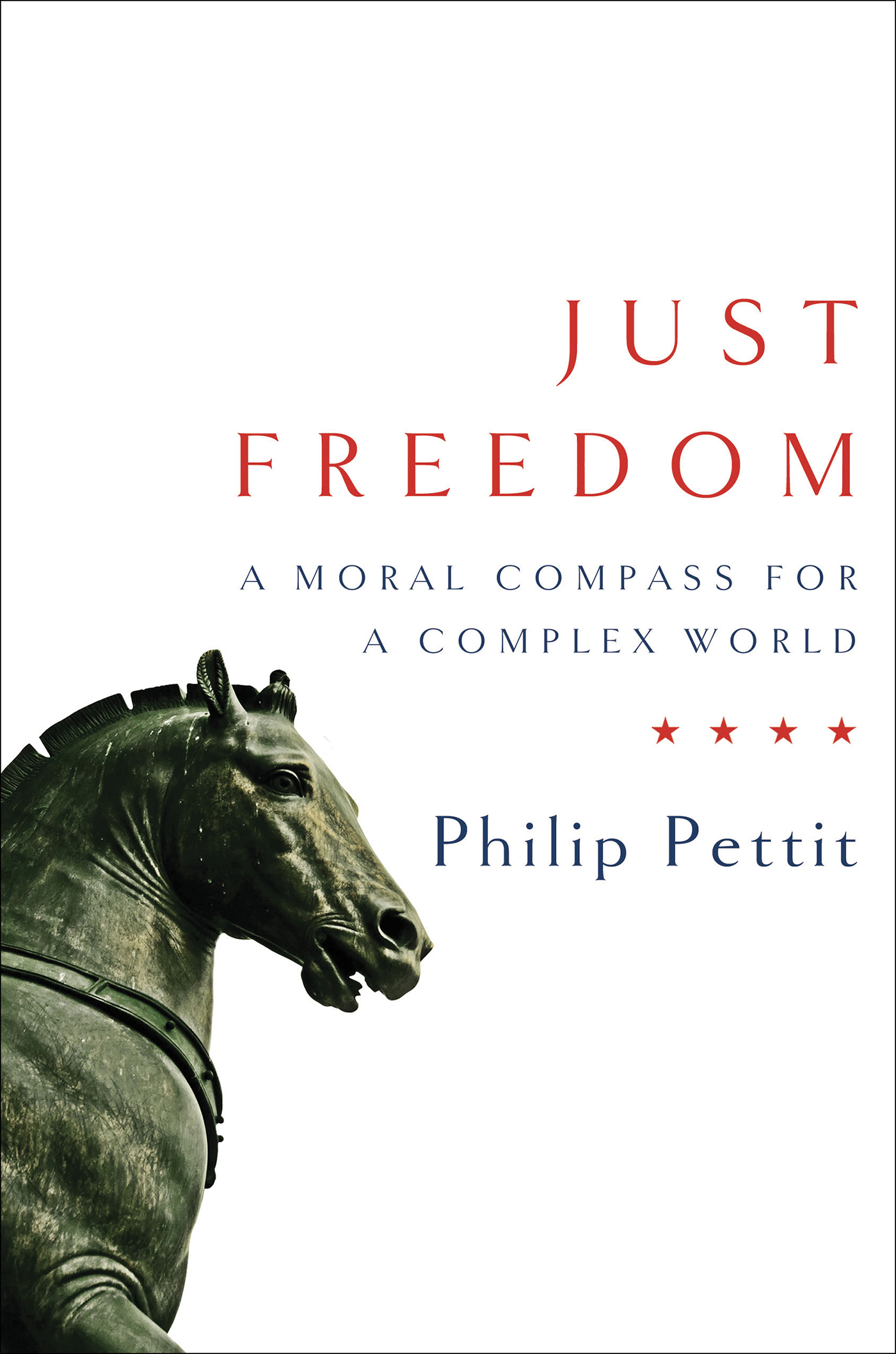
Just Freedom An esteemed philosopher offers a vision for the central role of one of our most cherished—and controversial—ideas. In this rigorous distillation of his political philosophy, Philip Pettit, author of the landmark work Republicanism, champions a simple standard for our most complex political judgments, offering a challenging ideal that nevertheless holds out a real prospect for social and democratic progress.Whereas many thinkers define freedom as the absence of interference—we are left alone to do as we please—Pettit demands that in their basic life choices free persons should not even be subject to a power of interference on the part of others. This notion of freedom as non-domination offers a yardstick for gauging social and democratic progress and provides a simple, unifying standard for analyzing our most entangled political quandaries. Pettit reaffirms the ideal, already present in the Roman Republic, of a free citizenry who enjoy equal status with one another, being individually protected by a law that they together control. After sketching a fresh history of freedom, he turns to the implications of the ideal for social, democratic, and international justice. Should the state erect systems for delivering mandatory healthcare coverage to its citizens? Should voting be a citizen’s only means of influencing political leaders? Are the demands of the United Nations to be heeded when they betray the sovereignty of the state? Pettit shows how these and other questions should be resolved within a civic republican perspective. Concise and elegant in its rhetoric and ultimately radical in its reimagining of our social arrangements, Just Freedom is neither a theoretical treatise nor a practical manifesto, but rather an ardent attempt to elaborate the demands of freedom and justice in our time. POLITICAL SCIENCE,Political Freedom
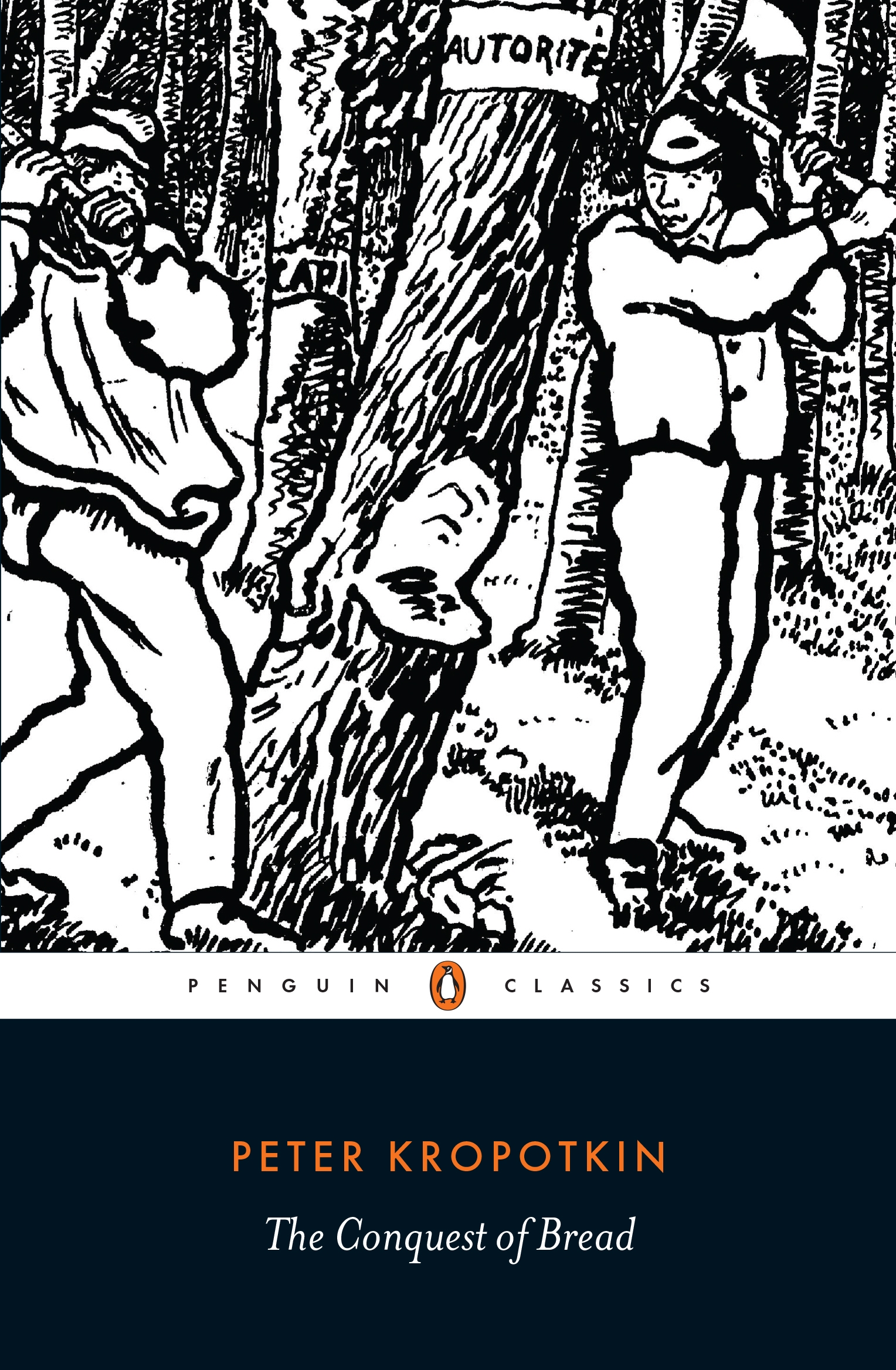
The Conquest of Bread 'Well-being for all is not a dream.' In this brilliantly enjoyable, challenging rallying-cry of a book, Kropotkin lays out the heart of his anarchist beliefs - beliefs which surged around the world in the late 19th and early 20th centuries and which have a renewed relevance and poignancy today. Humane, thoughtful - but also a devastating critique of how modern society is organized (with the brutal, narrow few clinging onto their wealth and privileges at the expense of the many), The Conquest of Bread is a book to be argued over, again and again. POLITICAL SCIENCE,Political Ideologies,Anarchism
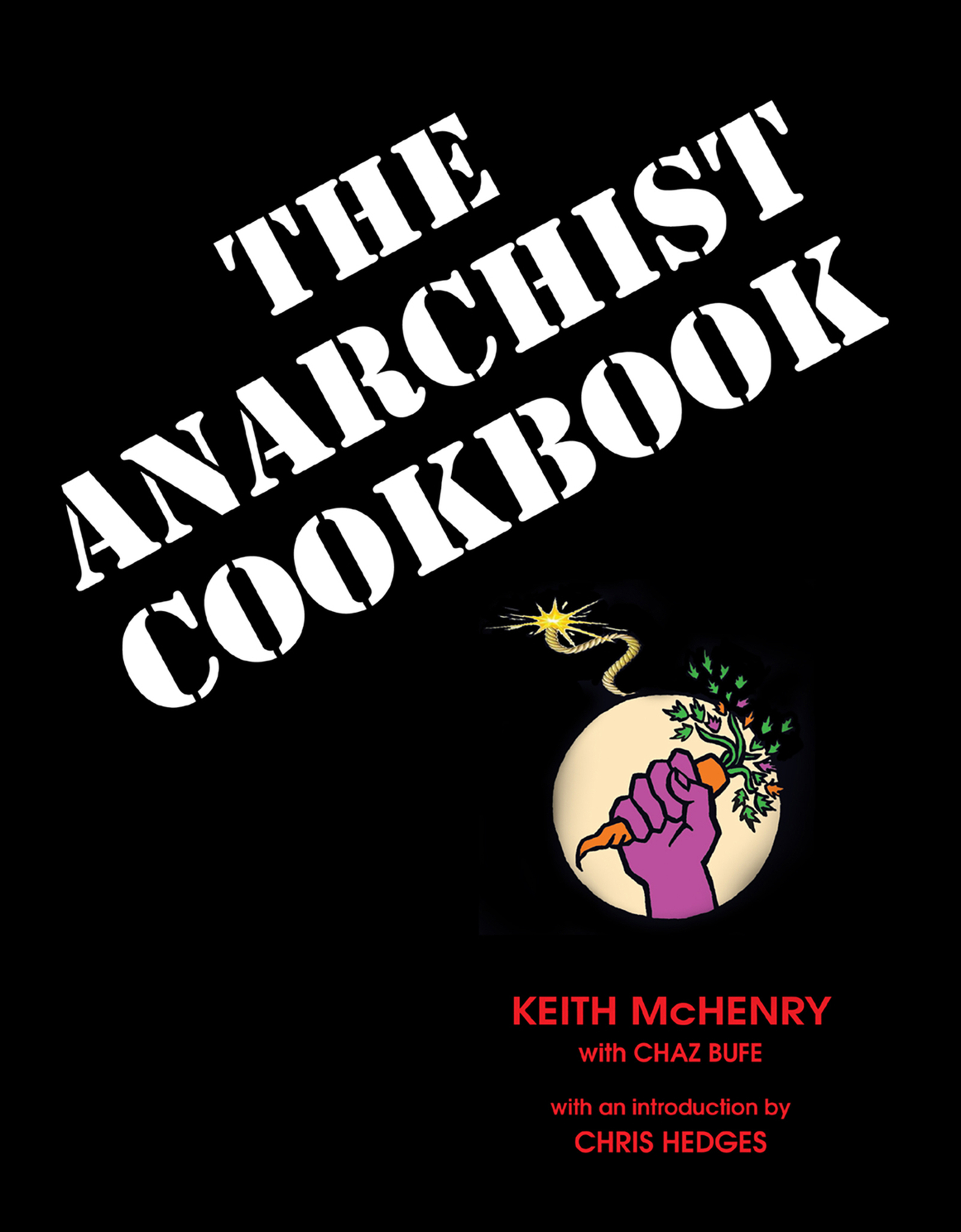
Anarchist Cookbook From the cofounder of Food Not Bombs, an action-oriented guide to anarchism, social change, and vegan cooking Unlike the original Anarchist Cookbook, which contained instructions for the manufacture of explosives, this version is both a cookbook in the literal sense and also a "cookbook" of recipes for social and political change. The coffee-table–sized book is divided into three sections: a theoretical section explaining what anarchism is and what it isn't; information on organizational principles and tactics for social and political change; and finally, numerous tasty vegan recipes from one of the cofounders of the international Food Not Bombs movement. POLITICAL SCIENCE,Political Ideologies,Anarchism

Society Of The Spectacle The Das Kapital of the 20th century,Society of the Spectacle is an essential text, and the main theoretical work of the Situationists. Few works of political and cultural theory have been as enduringly provocative. From its publication amid the social upheavals of the 1960's, in particular the May 1968 uprisings in France, up to the present day, with global capitalism seemingly staggering around in it’s Zombie end-phase, the volatile theses of this book have decisively transformed debates on the shape of modernity, capitalism, and everyday life in the late 20th century. This ‘Red and Black’ translation from 1977 is Introduced by Notting Hill armchair insurrectionary Tom Vague with a galloping time line and pop-situ verve, and given a more analytical over view by young upstart thinker Sam Cooper. POLITICAL SCIENCE,Political Ideologies,Anarchism

On Anarchism On Anarchism provides the reasoning behind Noam Chomsky's fearless lifelong questioning of the legitimacy of entrenched power. In these essays, Chomsky redeems one of the most maligned ideologies, anarchism, and places it at the foundation of his political thinking. Chomsky's anarchism is distinctly optimistic and egalitarian. Moreover, it is a living, evolving tradition that is situated in a historical lineage; Chomsky's anarchism emphasizes the power of collective, rather than individualist, action. The collection includes a revealing new introduction by journalist Nathan Schneider, who documented the Occupy movement for Harper's and The Nation, and who places Chomsky's ideas in the contemporary political moment. On Anarchism will be essential reading for a new generation of activists who are at the forefront of a resurgence of interest in anarchism—and for anyone who struggles with what can be done to create a more just world. POLITICAL SCIENCE,Political Ideologies,Anarchism

Anarchist Communism 'Everywhere you will find that the wealth of the wealthy springs from the poverty of the poor' Fuelled by anger at injustice and optimism about humankind's ability to make a better, truly communal society, the anarchist writings of Peter Kropotkin have influenced radicals the world over, from nineteenth-century workers to today's activists. One of twenty new books in the bestselling Penguin Great Ideas series. This new selection showcases a diverse list of thinkers who have helped shape our world today, from anarchists to stoics, feminists to prophets, satirists to Zen Buddhists. POLITICAL SCIENCE,Political Ideologies,Anarchism

Law as Refuge of Anarchy A study of communities in the Horn of Africa where reciprocity is a dominant social principle, offering a concrete countermodel to the hierarchical state. Over the course of history, people have developed many varieties of communal life; the state, with its hierarchical structure, is only one of the possibilities for society. In this book, leading anthropologist Hermann Amborn identifies a countermodel to the state, describing communities where reciprocity is a dominant social principle and where egalitarianism is a matter of course. He pays particular attention to such communities in the Horn of Africa, where nonhierarchical, nonstate societies exist within the borders of a hierarchical structured state. This form of community, Amborn shows, is not a historical forerunner to monarchy or the primitive state, nor is it obsolete as a social model. These communities offer a concrete counterexample to societies with strict hierarchical structures. Amborn investigates social forms of expression, ideas, practices, and institutions that oppose the hegemony of one group over another, exploring how conceptions of values and laws counteract tendencies toward the accumulation of power. He examines not only how the nonhegemonic ethos is reflected in law but also how anarchic social formations can exist. In the Horn of Africa, the autonomous jurisdiction of these societies protects against destructive outside influences, offers a counterweight to hegemonic violence, and contributes to the stabilization of communal life. In an era of widespread dissatisfaction with Western political systems, Amborn's study offers an opportunity to shift from traditional theories of anarchism and nonhegemony that project a stateless society to consider instead stateless societies already in operation. POLITICAL SCIENCE,Political Ideologies,Anarchism
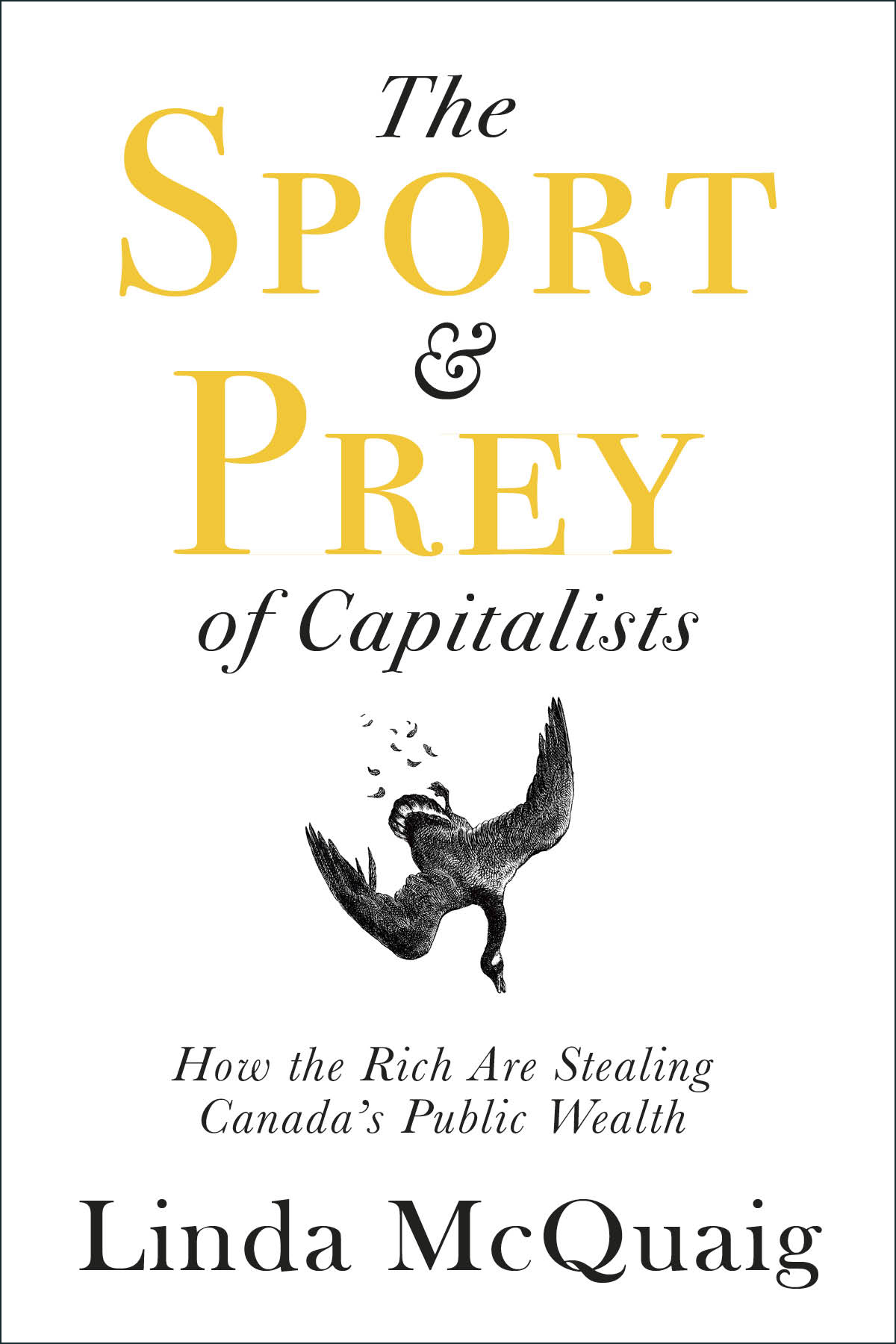
The Sport and Prey of Capitalists After more than a century as nation builders, Canadians have spent recent decades downsizing or selling off our ambitious public enterprises and programs to private investors, diminishing our ownership and control of key aspects of our economy, our country, and our lives. POLITICAL SCIENCE,Political Ideologies,Capitalism

The Case Against Socialism A recent poll showed 43% of Americans think more socialism would be a good thing. What do these people not know? Socialism has killed millions, but it’s now the ideology du jour on American college campuses and among many leftists. Reintroduced by leaders such as Bernie Sanders and Alexandria Ocasio-Cortez, the ideology manifests itself in starry-eyed calls for free-spending policies like Medicare-for-all and student loan forgiveness. In The Case Against Socialism, Rand Paul outlines the history of socialism, from Stalin’s gulags to the current famine in Venezuela. He tackles common misconceptions about the “utopia†of socialist Europe. As it turns out, Scandinavian countries love capitalism as much as Americans, and have, for decades, been cutting back on the things Bernie loves the most. Socialism’s return is only possible because many Americans have forgotten the true dangers of the twentieth-century’s deadliest ideology. Paul reveals the devastating truth: for every college student sporting a Che Guevara T-shirt, there’s a Venezuelan child dying of starvation. Desperate refugees flee communist Cuba to escape oppressive censorship, rationed food and squalid hospitals, not “free†healthcare. Socialist dictatorships like the People’s Republic of China crush freedom of speech and run massive surveillance states while masquerading as enlightened modern nations. Far from providing economic freedom, socialist governments enslave their citizens. They offer illusory promises of safety and equality while restricting personal liberty, tightening state power, sapping human enterprise and making citizens dependent on the dole. If socialism takes hold in America, it will imperil the fate of the world’s freest nation, unleashing a plague of oppressive government control. The Case Against Socialism is a timely response to that threat and a call to action against the forces menacing American liberty. POLITICAL SCIENCE,Political Ideologies,Capitalism
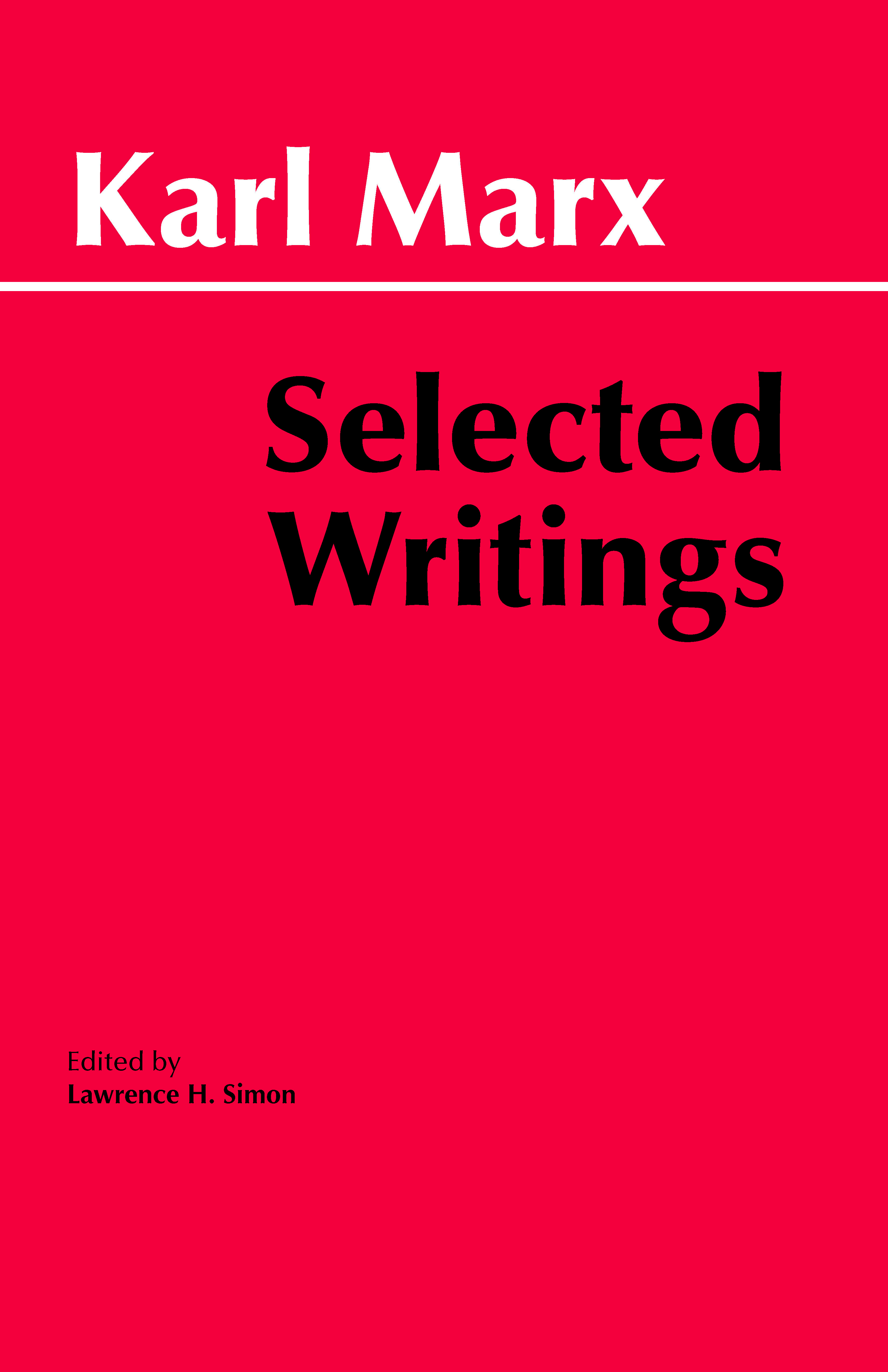
Marx Featuring the most important and enduring works from Marx's enormous corpus, this collection ranges from the Hegelian idealism of his youth to the mature socialism of his later works. Organized both topically and in rough chronological order, the selections (many of them in the translations of Loyd D. Easton and Kurt H. Guddat) include writings on historical materialism, excerpts from Capital, and political works. POLITICAL SCIENCE,Political Ideologies,Communism,Post-Communism & Socialism

Grundrisse Written during the winter of 1857-8, the Grundrisse was considered by Marx to be the first scientific elaboration of communist theory. A collection of seven notebooks on capital and money, it both develops the arguments outlined in the Communist Manifesto (1848) and explores the themes and theses that were to dominate his great later work Capital. Here, for the first time, Marx set out his own version of Hegel's dialectics and developed his mature views on labour, surplus value and profit, offering many fresh insights into alienation, automation and the dangers of capitalist society. Yet while the theories in Grundrisse make it a vital precursor to Capital, it also provides invaluable descriptions of Marx's wider-ranging philosophy, making it a unique insight into his beliefs and hopes for the foundation of a communist state. POLITICAL SCIENCE,Political Ideologies,Communism,Post-Communism & Socialism
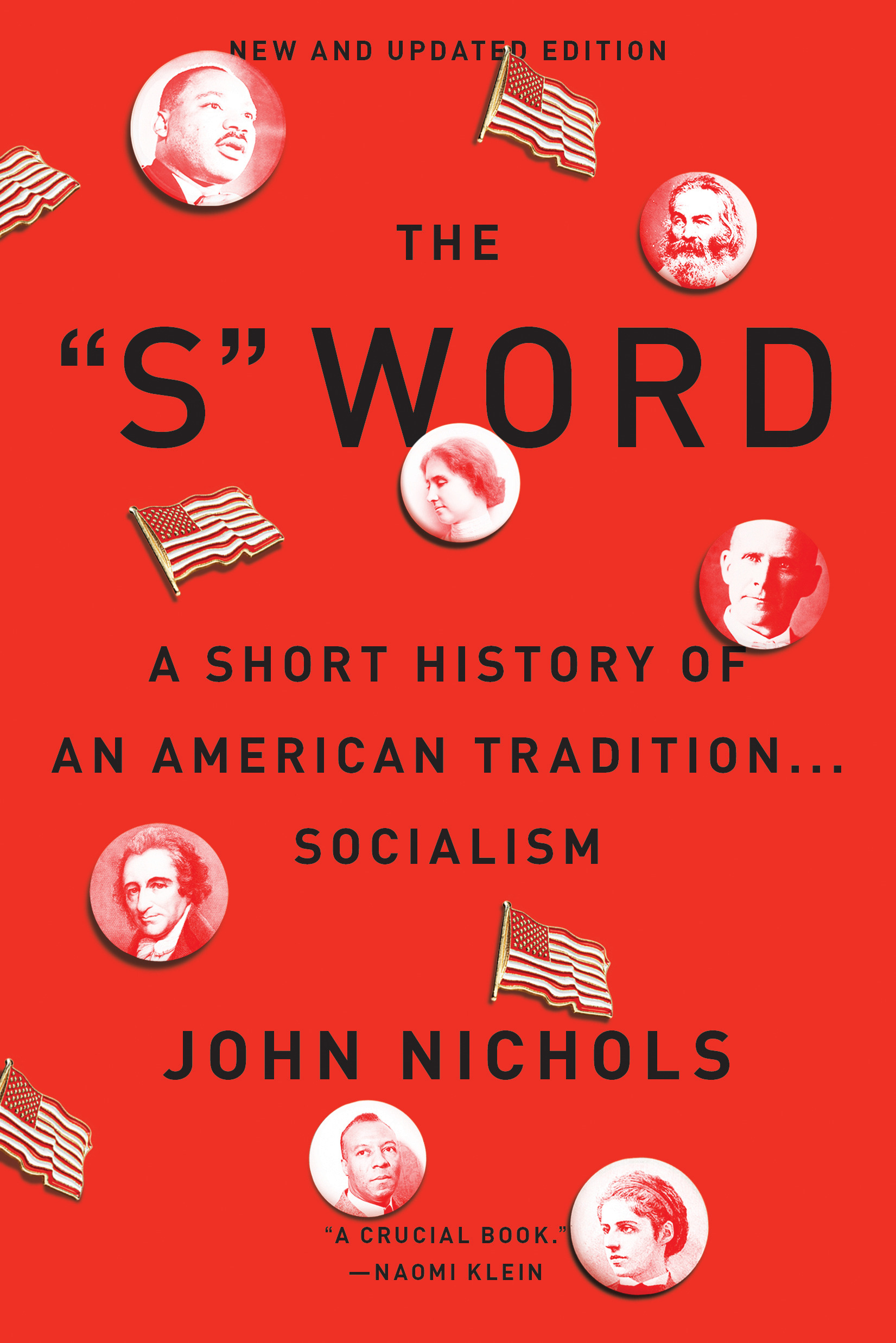
The S Word A few months before the 2010 midterms, Newt Gingrich described the socialist infiltration of American government and media as “even more disturbing than the threats from foreign terrorists.” John Nichols offers an unapologetic retort to the return of red-baiting in American political life—arguing that socialism has a long, proud, American history. Tom Paine was enamored of early socialists, Horace Greeley employed Karl Marx as a correspondent, and Helen Keller was an avowed socialist. The “S” Word gives Americans back a crucial aspect of their past and makes a forthright case for socialist ideas today. POLITICAL SCIENCE,Political Ideologies,Communism,Post-Communism & Socialism

The Communist Manifesto In the two decades following the fall of the Berlin Wall, global capitalism became entrenched in its modern, neoliberal form. Its triumph was so complete that the word “capitalism” itself fell out of use in the absence of credible political alternatives. But with the outbreak of financial crisis and global recession in the twenty-first century, capitalism is once again up for discussion. The status quo can no longer be taken for granted. As Eric Hobsbawm argues in his acute and elegant introduction to this modern edition, in such times The Communist Manifesto emerges as a work of great prescience and power despite being written over a century and a half ago. He highlights Marx and Engels’s enduring insights into the capitalist system: its devastating impact on all aspects of human existence; its susceptibility to enormous convulsions and crises; and its fundamental weakness. POLITICAL SCIENCE,Political Ideologies,Communism,Post-Communism & Socialism
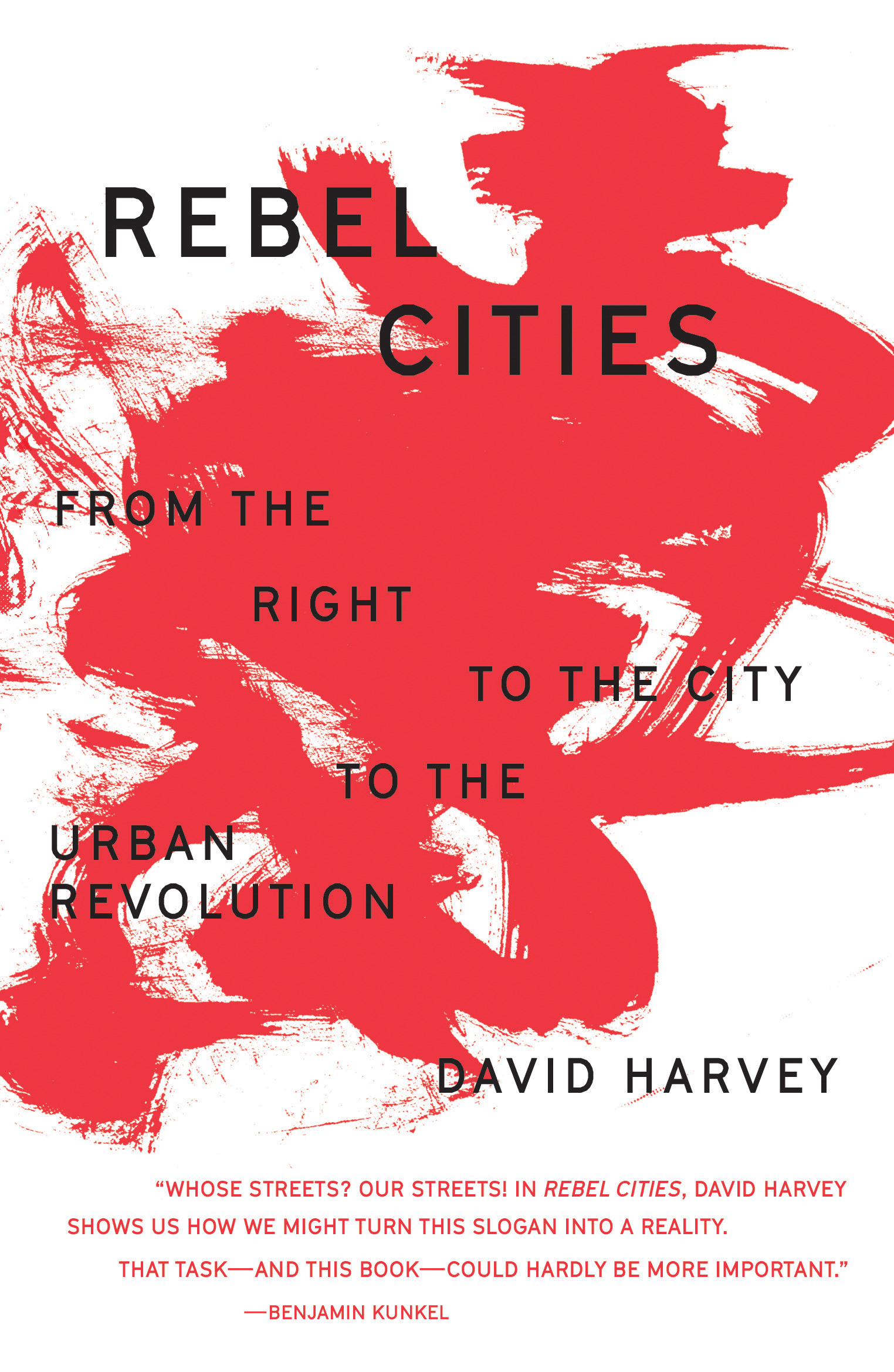
Rebel Cities Long before the Occupy movement, modern cities had already become the central sites of revolutionary politics, where the deeper currents of social and political change rise to the surface. Consequently, cities have been the subject of much utopian thinking. But at the same time they are also the centers of capital accumulation and the frontline for struggles over who controls access to urban resources and who dictates the quality and organization of daily life. Is it the financiers and developers, or the people? Rebel Cities places the city at the heart of both capital and class struggles, looking at locations ranging from Johannesburg to Mumbai, and from New York City to São Paulo. Drawing on the Paris Commune as well as Occupy Wall Street and the London Riots, Harvey asks how cities might be reorganized in more socially just and ecologically sane ways—and how they can become the focus for anti-capitalist resistance. POLITICAL SCIENCE,Political Ideologies,Communism,Post-Communism & Socialism
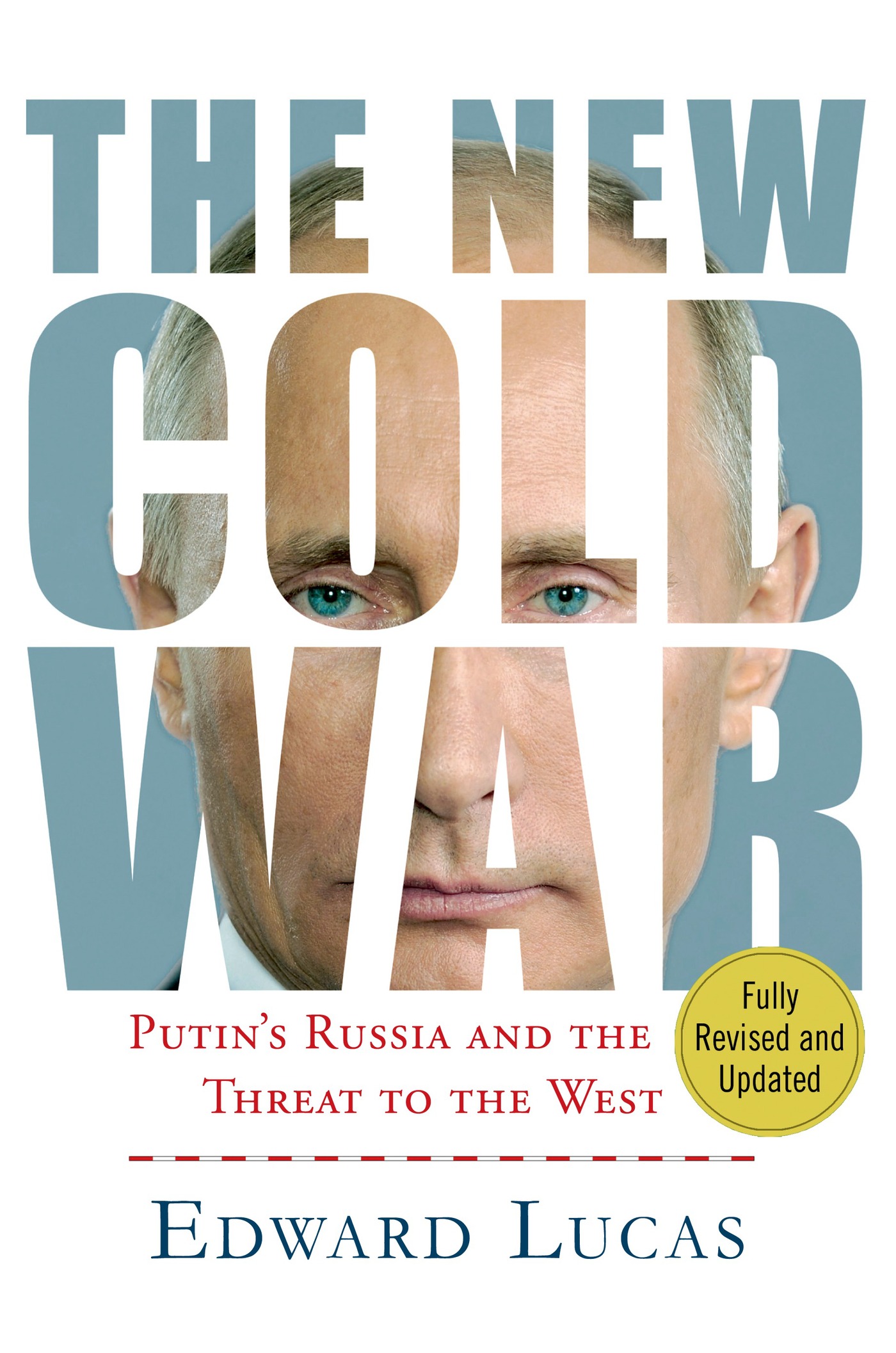
The New Cold War The first edition of The New Cold War was published to great critical acclaim. Edward Lucas has established himself as a top expert in the field, appearing on numerous programs, including Lou Dobbs, MSNBC, NBC Nightly News, CNN, and NPR. Since The New Cold War was first published in February 2008, Russia has become more authoritarian and corrupt, its institutions are weaker, and reforms have fizzled. In this revised and updated third edition, Lucas includes a new preface on the Crimean crisis, including analysis of the dismemberment of Ukraine, and a look at the devastating effects it may have from bloodshed to economic losses. Lucas reveals the asymmetrical relationship between Russia and the West, a result of the fact that Russia is prepared to use armed force whenever necessary, while the West is not. Hard-hitting and powerful, The New Cold War is a sobering look at Russia's current aggression and what it means for the world. This edition includes 30% updated material. It is also fully updated to include an incisive analysis of the Crimean crisis, from Russia's seizure of the region to the dismemberment of Ukraine. POLITICAL SCIENCE,Political Ideologies,Communism,Post-Communism & Socialism

Ethical Dimensions of Marxist Thought Esteemed American philosopher, Cornel West tackles the ethics of the Marxism agenda In this fresh, original analysis of Marxist thought, Cornel West makes a significant contribution to today's debates about the relevance of Marxism by putting the issue of ethics squarely on the Marxist agenda. West, professor of religion and director of the Afro-American studies program at Princeton University, shows that not only was ethics an integral part of the development of Marx's own thinking throughout his career, but that this crucial concern has been obscured by such leading and influential interpreters as Engels, Kautsky, Luk?cs, and others who diverted Marx's theory into narrow forms of positivism, economism, and Hegelianism. POLITICAL SCIENCE,Political Ideologies,Communism,Post-Communism & Socialism

The Communist Manifesto In a world where capitalism is no longer held in check by fear of a communist alternative, The Communist Manifesto (with Socialism Utopian and Scientific, Engels's brief and clear exposition of Marxist thought) is essential reading. The Condition of the Working Class in England in 1844 is Engels's first, and probably best-known, book. POLITICAL SCIENCE,Political Ideologies,Communism,Post-Communism & Socialism

Profanations The Italian philosopher Giorgio Agamben has always been an original reader of texts, understanding their many rich and multiple historical, aesthetic, and political meanings and effects. In Profanations, Agamben has assembled for the first time some of his most pivotal essays on photography, the novel, and film. A meditation on memory and oblivion, on what is lost and what remains, Profanations proves yet again that Agamben is one of the most provocative writers of our times. In ten essays, Agamben rethinks approaches to a series of literary and philosophical problems: the relation between genius, ego, and theories of subjectivity; the problem of messianic time as explicated in both images and lived experience; parody as a literary paradigm; the potential of magic to provide an ethical canon. The range of topics and themes addressed here attest to the very creativity of Agamben’s singular mode of thought and his persistent pursuit to grasp the act of witnessing, sometimes futile, sometimes earth-shattering — the talking cricket in Pinocchio; “helpers†in Kafka’s novels; pictorial representations of the Last Judgment, of anonymous female faces, and of Orson Wells’s infamous object of obsession Rosebud. “In Praise of Profanity,†the central essay of this small but dense book, confronts the question of profanity as the crucial political task of the moment. An act of resistance to every form of separation, the concept of profanation — as both the “return to common usage†and “sacrifice†— reorients perceptions of how power, consumption, and use interweave to produce an urgent political modality and desire: to profane the unprofanable. In short, Agamben provides not only a new and potent theoretical model but also a writerly style that itself forges inescapable links between literature, politics, and philosophy. POLITICAL SCIENCE,Political Ideologies,Communism,Post-Communism & Socialism

The Nordic Theory of Everything A Finnish journalist, now a naturalized American citizen, asks Americans to draw on elements of the Nordic way of life to nurture a fairer, happier, more secure, and less stressful society for themselves and their children Moving to America in 2008, Finnish journalist Anu Partanen quickly went from confident, successful professional to wary, self-doubting mess. She found that navigating the basics of everyday life—from buying a cell phone and filing taxes to education and childcare—was much more complicated and stressful than anything she encountered in her homeland. At first, she attributed her crippling anxiety to the difficulty of adapting to a freewheeling new culture. But as she got to know Americans better, she discovered they shared her deep apprehension. To understand why life is so different in the U.S. and Finland, Partanen began to look closely at both. In The Nordic Theory of Everything, Partanen compares and contrasts life in the United States with life in the Nordic region, focusing on four key relationships—parents and children, men and women, employees and employers, and government and citizens. She debunks criticism that Nordic countries are socialist “nanny states,†revealing instead that it is we Americans who are far more enmeshed in unhealthy dependencies than we realize. As Partanen explains step by step, the Nordic approach allows citizens to enjoy more individual freedom and independence than we do. Partanen wants to open Americans’ eyes to how much better things can be—to show her beloved new country what it can learn from her homeland to reinvigorate and fulfill the promise of the American dream—to provide the opportunity to live a healthy, safe, economically secure, upwardly mobile life for everyone. Offering insights, advice, and solutions, The Nordic Theory of Everything makes a convincing argument that we can rebuild our society, rekindle our optimism, and restore true freedom to our relationships and lives. POLITICAL SCIENCE,Political Ideologies,Communism,Post-Communism & Socialism
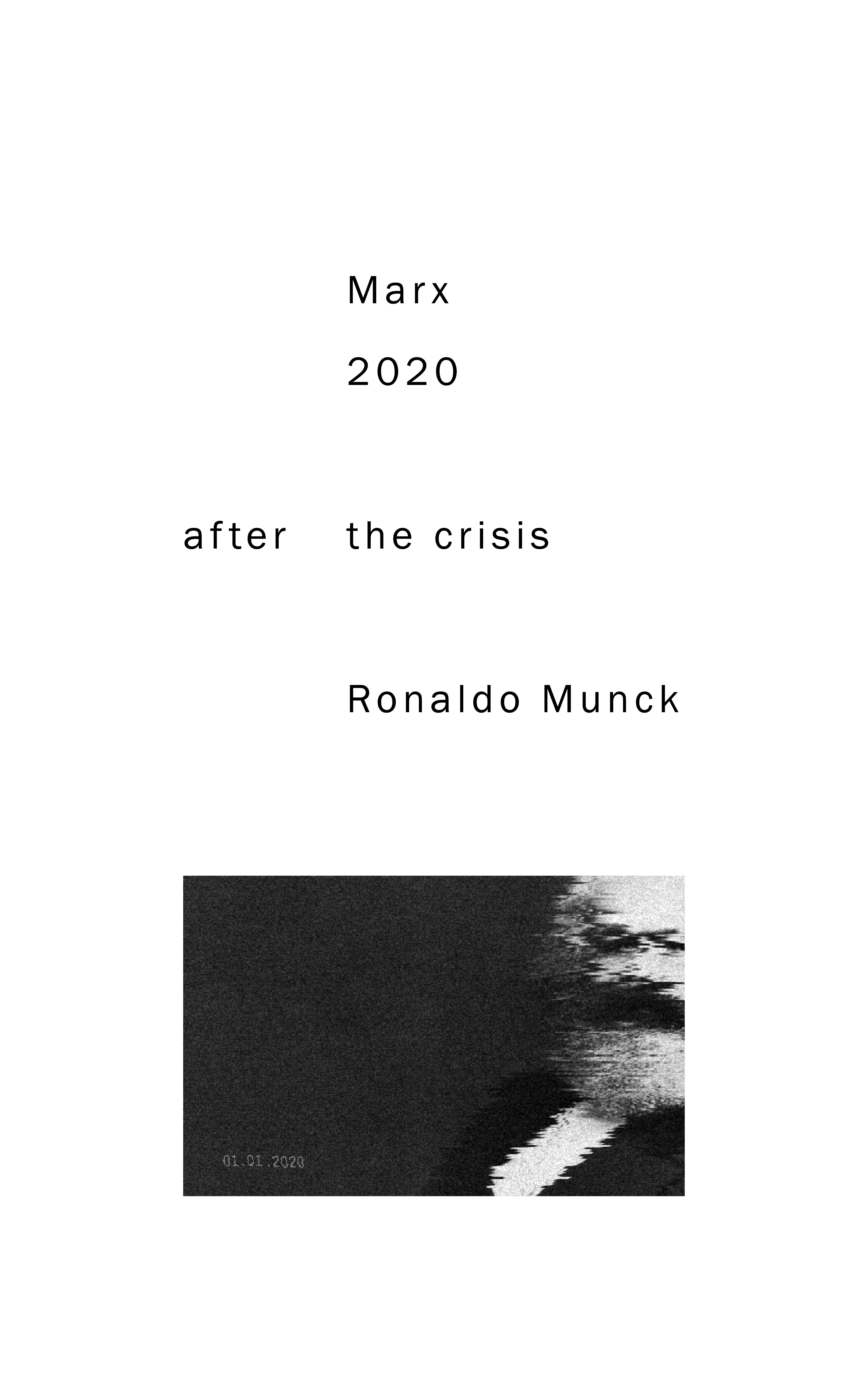
Marx 2020 An accessible and comprehensive overview of Marxism after the 2008 financial crisis, and its continued relevance to social and political debate in the 21st century. POLITICAL SCIENCE,Political Ideologies,Communism,Post-Communism & Socialism

Modern Imperialism, Monopoly Finance Capital, and Marx's Law of Value The complete collection of Samir Amin's work on Marxism value theory Unlike such obvious forms of oppression as feudalism or slavery, capitalism has been able to survive through its genius for disguising corporate profit imperatives as opportunities for individual human equality and advancement. But it was the genius of Karl Marx, in his masterwork, Capital, to discover the converse law of surplus value: behind the illusion of the democratic, supply-and-demand marketplace, lies the workplace, where people trying to earn a living are required to work way beyond the time it takes to pay their wages. Leave it to the genius of Samir Amin to advance Marx's theories—adding to them the work of radical economists such as Michal Kalecki, Josef Steindl, Paul Baran, and Paul Sweezy—to show how Marxian theory can be adapted to modern economic conditions. Amin extends Marx's analysis to describe a concept of “imperialist rent†derived from the radically unequal wages paid for the same labor done by people in both the Global North and the Global South, the rich nations and the poor ones. This is global oligopolistic capitalism, in which finance capital has come to dominate worldwide production and distribution. Amin also advances Baran and Sweezy’s notion of economic surplus to explain a globally monopolized system in which Marx's “law of value†takes the form of a “law of globalized value,†generating a super-exploitation of workers in the Global South. Modern Imperialism, Monopoly Finance Capital, and Marx's Law of Value offers readers, in one volume, the complete collection of Samir Amin’s work on Marxian value theory. The book includes texts from two of Amin's recent works, Three Essays on Marx’s Value Theory and The Law of Worldwide Value, which have provoked considerable controversy and correspondence. Here, Amin answers his critics with a series of letters, clarifying and developing his ideas. This work will occupy an important place among the theoretical resources for anyone involved in the study of contemporary Marxian economic and political theory. POLITICAL SCIENCE,Political Ideologies,Communism,Post-Communism & Socialism
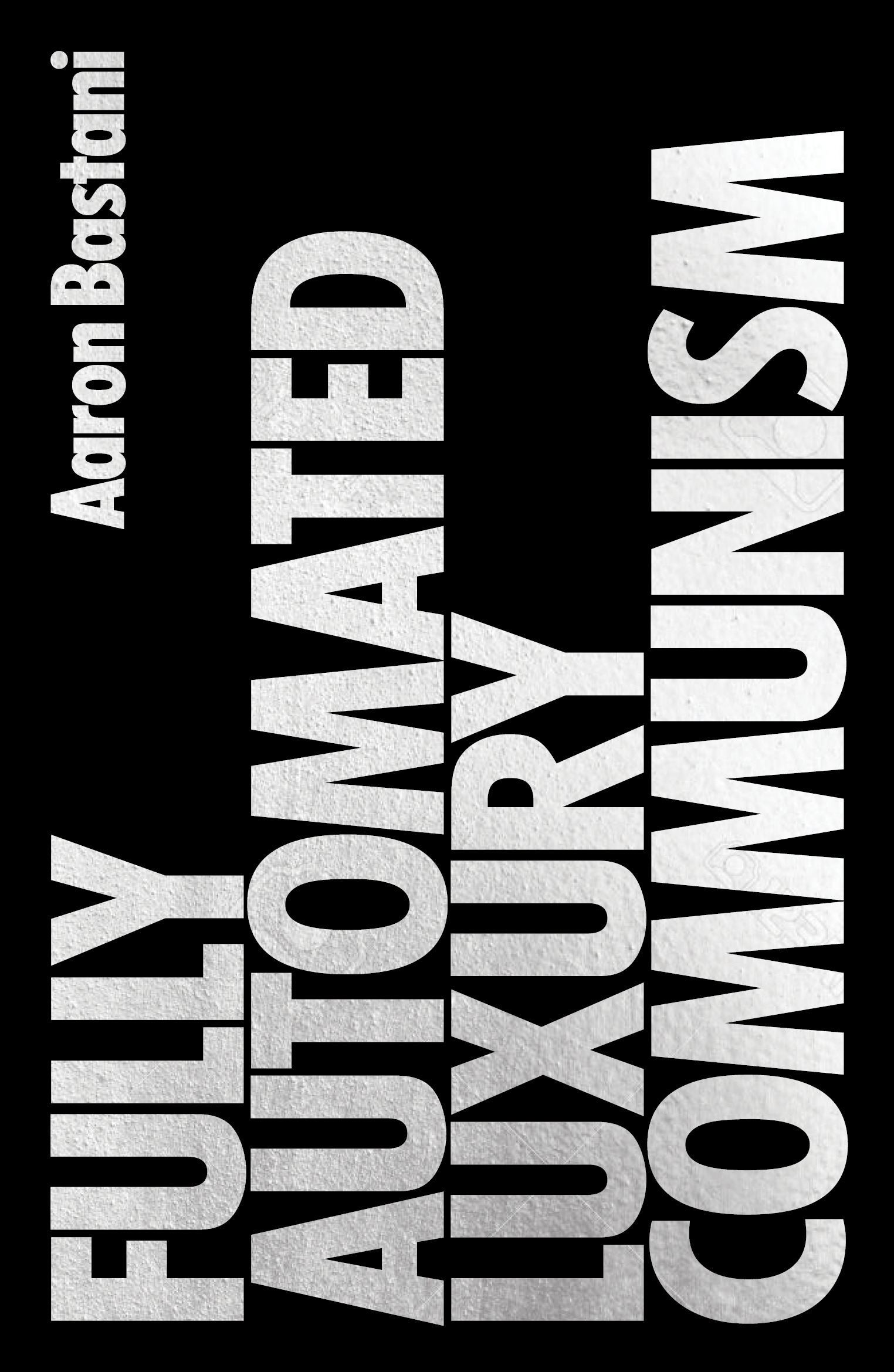
Fully Automated Luxury Communism A different kind of politics for a new kind of society--beyond work, scarcity and capitalism In the twenty-first century, new technologies should liberate us from work. Automation, rather than undermining an economy built on full employment, is instead the path to a world of liberty, luxury and happiness—for everyone. Technological advance will reduce the value of commodities—food, healthcare and housing—towards zero. Improvements in renewable energies will make fossil fuels a thing of the past. Asteroids will be mined for essential minerals. Genetic editing and synthetic biology will prolong life, virtually eliminate disease and provide meat without animals. New horizons beckon. In Fully Automated Luxury Communism, Aaron Bastani conjures a vision of extraordinary hope, showing how we move to energy abundance, feed a world of 9 billion, overcome work, transcend the limits of biology, and establish meaningful freedom for everyone. Rather than a final destination, such a society merely heralds the real beginning of history. POLITICAL SCIENCE,Political Ideologies,Communism,Post-Communism & Socialism
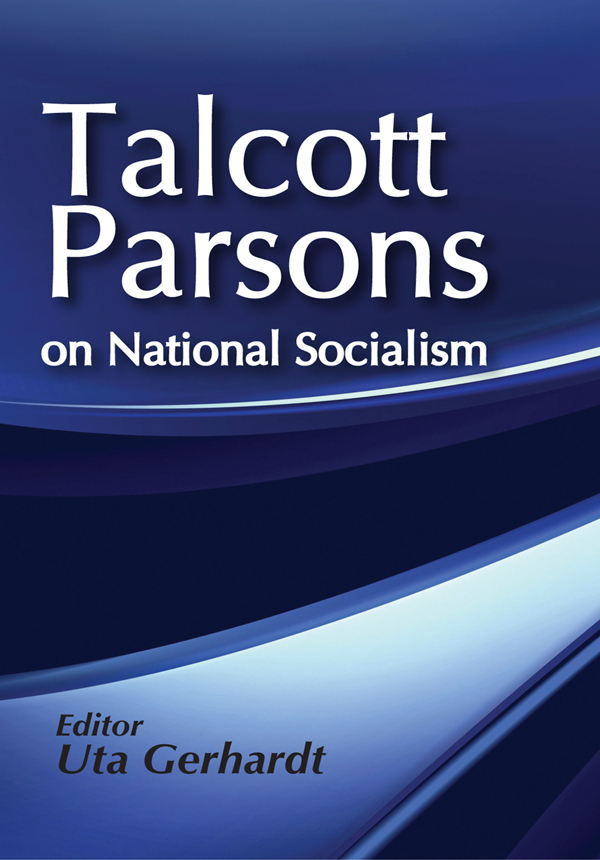
On National Socialism During the years between the publication of the first of his two major works, The Structure of Social Action (1937), and the writing of his second, The Social System (1951), Talcott Parsons was primarily engaged in political activity through the Office of Strategic Services in its efforts to bring about the defeat of the Third Reich and to set the stage for a democratic reconstruction of postwar Germany. Beyond Parsons' analytic skills the essays reveal a dedicated liberal scholar, far removed from the stereotypes with which he came to be pilloried by later critics. The essays in this collection are the by-products of that special period of intense commitment. They reflect a single dominant theme: National Socialist Germany is seen as a tragically flawed social system but one requiring the same rigorous analysis Parsons brought to more normal and normative systems. Since virulent authoritarianism and even more virulent anti-Semitism were the dominant traits of that system as he saw it, Parsons dedicated many pages to each aspect. While he did not know the full horror of the Nazi ""war against the Jews"" he was able to develop a theoretical framework that continues to be a foundation stone for the analysis of national socialism. Gerhardt's editorial labors in the Parsons archive at Harvard have yielded nothing less than a ""new book"" by the foremost American sociological theorist of his time. This collection of both published and unpublished writings conveys Parsons' cohesive intent. To these otherwise fugitive and neglected essays Gerhardt contributes an introductory essay of her own: in part biography, in part intellectual and social history. She discovered Parsons work on National Socialism while studying his sociology of the professions and his use of medical practice to demonstrate how social science could become an antidote for fascism and authoritarianism. Uta Gerhardt is director of the Medical Sociology Unit at Justu POLITICAL SCIENCE,Political Ideologies,Communism,Post-Communism & Socialism

The Management of Savagery The rise of international jihad and Western ultra-nationalism In the Management of Savagery, Max Blumenthal excavates the real story behind America’s dealings with the world and shows how the extremist forces that now threaten peace across the globe are the inevitable flowering of America’s imperial designs. Washington’s secret funding of the mujahedin provoked the Russian invasion of Afghanistan in 1979. With guns and money, the United States has ever since sustained the extremists, including Osama Bin Laden, who have become its enemies. The Pentagon has trained and armed jihadist elements in Afghanistan, Syria, and Libya; it has launched military interventions to change regimes in the Middle East. In doing so, it created fertile ground for the Islamic State and brought foreign conflicts home to American soil. These failed wars abroad have made the United States more vulnerable to both terrorism as well as native ultra-nationalism. The Trump presidency is the inevitable consequence of neoconservative imperialism in the post–Cold War age. Trump’s dealings in the Middle East are likely only to exacerbate the situation. POLITICAL SCIENCE,Political Ideologies,Communism,Post-Communism & Socialism

All-American Nativism American history told from the vantage of immigration politics It is often said that with the election of Donald Trump nativism was raised from the dead. After all, here was a president who organized his campaign around a rhetoric of unvarnished racism and xenophobia. Among his first acts on taking office was to block foreign nationals from seven predominantly Muslim countries from entering the United States. But although his actions may often seem unprecedented, they are not as unusual as many people believe. This story doesn’t begin with Trump. For decades, Republicans and Democrats alike have employed xenophobic ideas and policies, declaring time and again that “illegal immigration” is a threat to the nation’s security, wellbeing, and future. The profound forces of all-American nativism have, in fact, been pushing politics so far to the right over the last forty years that, for many people, Trump began to look reasonable. As Daniel Denvir argues, issues as diverse as austerity economics, free trade, mass incarceration, the drug war, the contours of the post 9/11 security state, and, yes, Donald Trump and the Alt-Right movement are united by the ideology of nativism, which binds together assorted anxieties and concerns into a ruthless political project. All-American Nativism provides a powerful and impressively researched account of the long but often forgotten history that gave us Donald Trump. POLITICAL SCIENCE,Political Ideologies,Communism,Post-Communism & Socialism

Can the Working Class Change the World? An analysis of how the working class can mobilize as a force for change in the present day One of the horrors of the capitalist system is that slave labor, which was central to the formation and growth of capitalism itself, is still fully able to coexist alongside wage labor. But, as Karl Marx points out, it is the fact of being paid for one's work that validates capitalism as a viable socio-economic structure. Beneath this veil of “free commerce†– where workers are paid only for a portion of their workday, and buyers and sellers in the marketplace face each other as “equals†– lies a foundation of immense inequality. Yet workers have always rebelled. They've organized unions, struck, picketed, boycotted, formed political organizations and parties – sometimes they have actually won and improved their lives. But, Marx argued, because capitalism is the apotheosis of class society, it must be the last class society: it must, therefore, be destroyed. And only the working class, said Marx, is capable of creating that change. In his timely and innovative book, Michael D. Yates asks if the working class can, indeed, change the world. Deftly factoring in such contemporary elements as sharp changes in the rise of identity politics and the nature of work, itself, Yates asks if there can, in fact, be a thing called the working class? If so, how might it overcome inherent divisions of gender, race, ethnicity, religion, location – to become a cohesive and radical force for change? Forcefully and without illusions, Yates supports his arguments with relevant, clearly explained data, historical examples, and his own personal experiences. This book is a sophisticated and prescient understanding of the working class, and what all of us might do to change the world. POLITICAL SCIENCE,Political Ideologies,Communism,Post-Communism & Socialism

Why Women Have Better Sex Under Socialism A spirited, deeply researched exploration of why capitalism is bad for women and how, when done right, socialism leads to economic independence, better labor conditions, better work-life balance and, yes, even better sex. In a witty, irreverent op-ed piece that went viral, Kristen Ghodsee argued that women had better sex under socialism. The response was tremendous -- clearly she articulated something many women had sensed for years: the problem is with capitalism, not with us. Ghodsee, an acclaimed ethnographer and professor of Russian and East European Studies, spent years researching what happened to women in countries that transitioned from state socialism to capitalism. She argues here that unregulated capitalism disproportionately harms women, and that we should learn from the past. By rejecting the bad and salvaging the good, we can adapt some socialist ideas to the 21st century and improve our lives. She tackles all aspects of a woman's life - work, parenting, sex and relationships, citizenship, and leadership. In a chapter called "Women: Like Men, But Cheaper," she talks about women in the workplace, discussing everything from the wage gap to harassment and discrimination. In "What To Expect When You're Expecting Exploitation," she addresses motherhood and how "having it all" is impossible under capitalism. Women are standing up for themselves like never before, from the increase in the number of women running for office to the women's march to the long-overdue public outcry against sexual harassment. Interest in socialism is also on the rise -- whether it's the popularity of Bernie Sanders or the skyrocketing membership numbers of the Democratic Socialists of America. It's become increasingly clear to women that capitalism isn't working for us, and Ghodsee is the informed, lively guide who can show us the way forward. POLITICAL SCIENCE,Political Ideologies,Communism,Post-Communism & Socialism
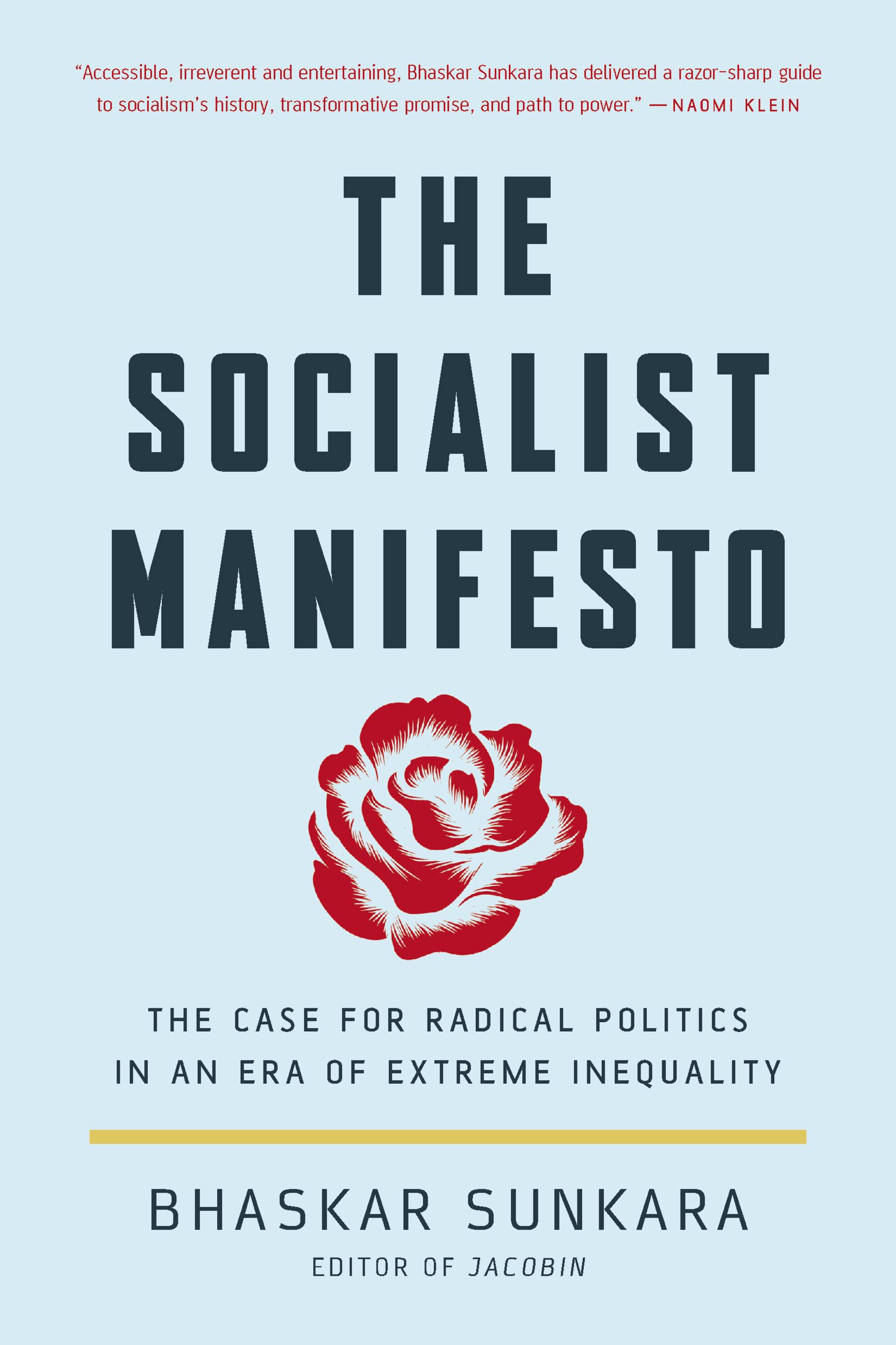
The Socialist Manifesto A "razor-sharp" introduction to this political and economic ideology makes a galvanizing argument for modern socialism (Naomi Klein) -- and explains how its core tenets could effect positive change in America and worldwide. In The Socialist Manifesto, Bhaskar Sunkara explores socialism's history since the mid-1800s and presents a realistic vision for its future. With the stunning popularity of Bernie Sanders and Alexandria Ocasio-Cortez, Americans are embracing the class politics of socialism. But what, exactly, is socialism? And what would a socialist system in America look like? The editor of Jacobin magazine, Sunkara shows that socialism, though often seen primarily as an economic system, in fact offers the means to fight all forms of oppression, including racism and sexism. The ultimate goal is not Soviet-style planning, but to win rights to healthcare, education, and housing, and to create new democratic institutions in workplaces and communities. A primer on socialism for the 21st century, this is a book for anyone seeking an end to the vast inequities of our age. POLITICAL SCIENCE,Political Ideologies,Communism,Post-Communism & Socialism
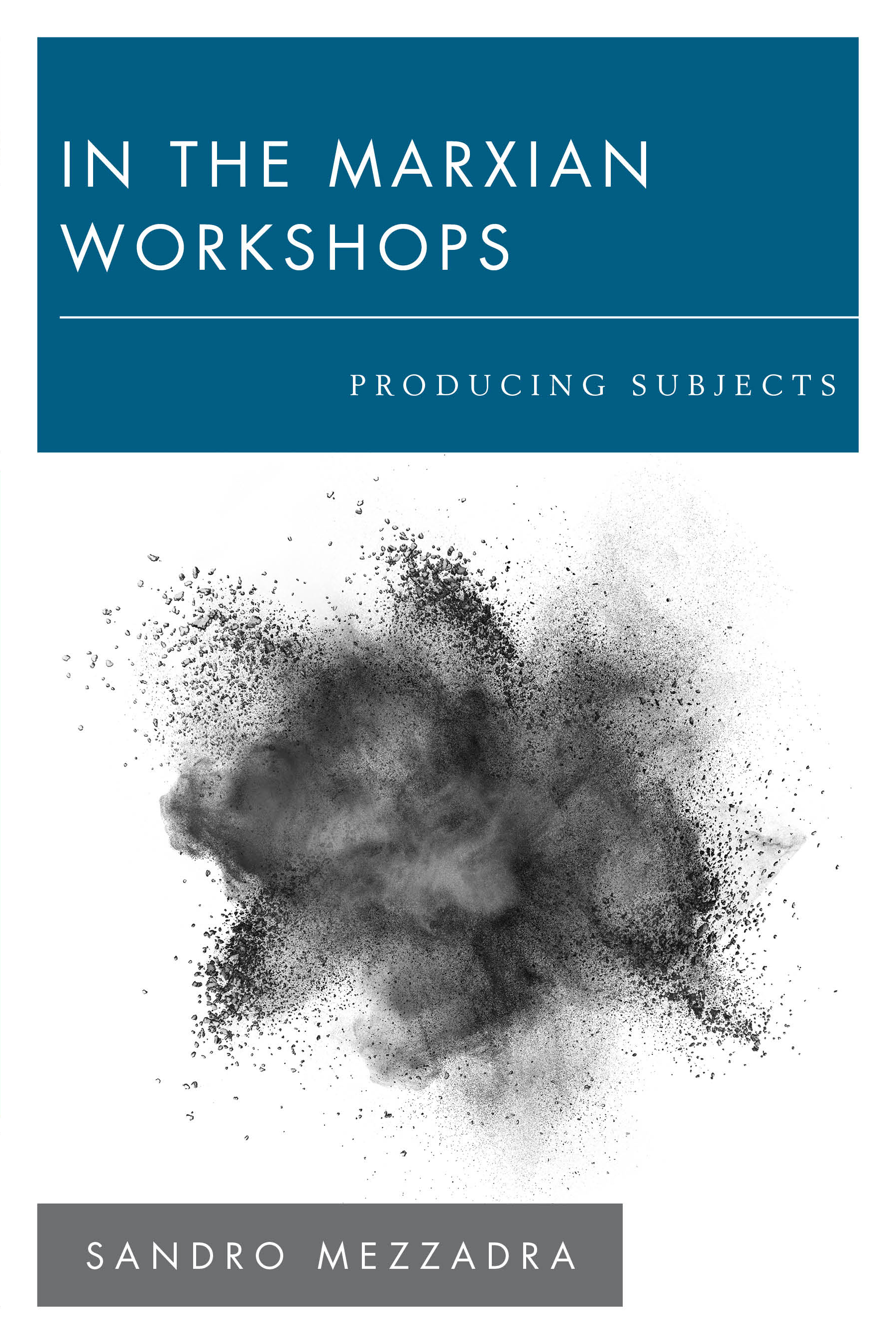
In the Marxian Workshops Brings together a close reading of Marx texts with contemporary debates on the production of subjectivity and offers a critical and postcolonial perspective on the subjectivity of labour, and contemporary capitalism. POLITICAL SCIENCE,Political Ideologies,Communism,Post-Communism & Socialism
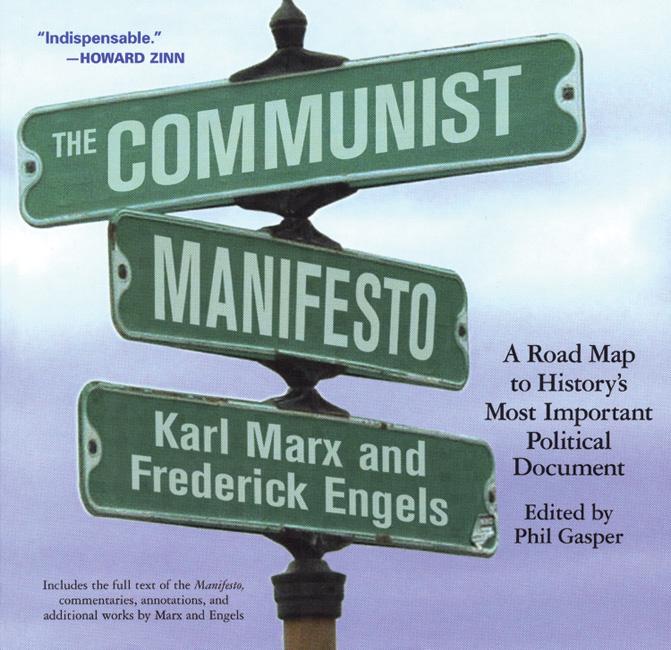
The Communist Manifesto An authoritative introduction to history's most important political document, with the full text of the Manifesto. POLITICAL SCIENCE,Political Ideologies,Communism,Post-Communism & Socialism
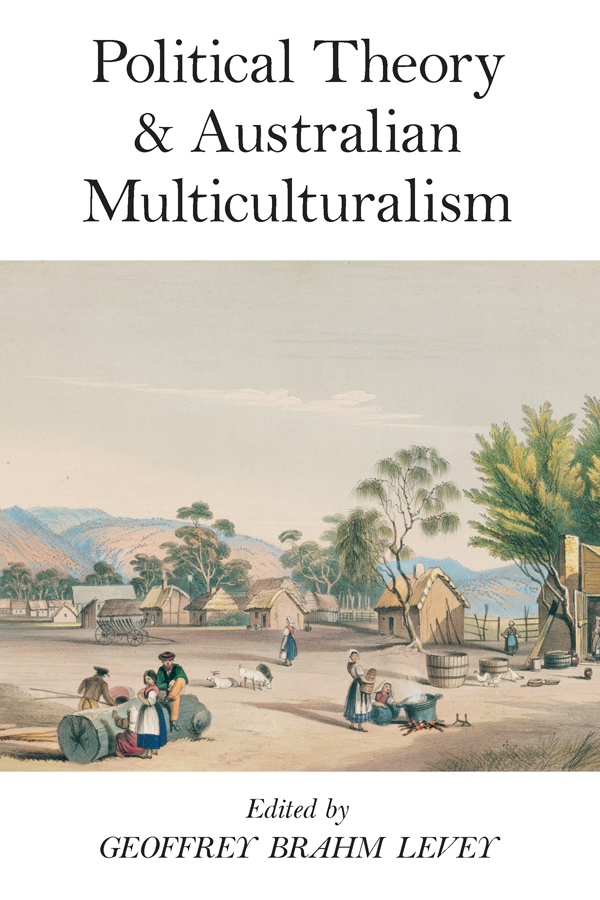
Political Theory and Australian Multiculturalism Multiculturalism has been one of the dominant concerns in political theory over the last decade. To date, this inquiry has been mostly informed by, or applied to, the Canadian, American, and increasingly, the European contexts. This volume explores for the first time how the Australian experience both relates and contributes to political thought on multiculturalism. Focusing on whether a multicultural regime undermines political integration, social solidarity, and national identity, the authors draw on the Australian case to critically examine the challenges, possibilities, and limits of multiculturalism as a governing idea in liberal democracies. These essays by distinguished Australian scholars variously treat the relation between liberalism and diversity, democracy and diversity, culture and rights, and evaluate whether Australia’s thirty-year experiment in liberal multiculturalism should be viewed as a successful model. POLITICAL SCIENCE,Political Ideologies,Communism,Post-Communism & Socialism
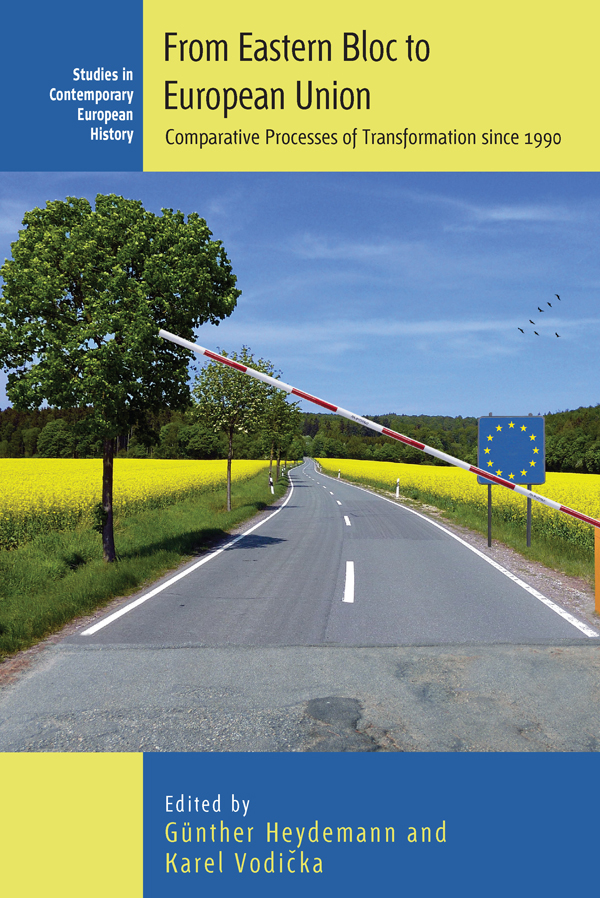
From Eastern Bloc to European Union More than 25 years after the fall of the Soviet Union, European integration remains a work in progress, especially in those Eastern European nations most dramatically reshaped by democratization and economic liberalization. This volume assembles detailed, empirically grounded studies of eleven states—Estonia, Latvia, Lithuania, Poland, the Czech Republic, Slovakia, Hungary, Romania, Bulgaria, Slovenia, and the former East Germany—that went on to join the European Union. Each chapter analyzes the political, economic, and social transformations that have taken place in these nations, using a comparative approach to identify structural similarities and assess outcomes relative to one another as well as the rest of the EU. POLITICAL SCIENCE,Political Ideologies,Communism,Post-Communism & Socialism
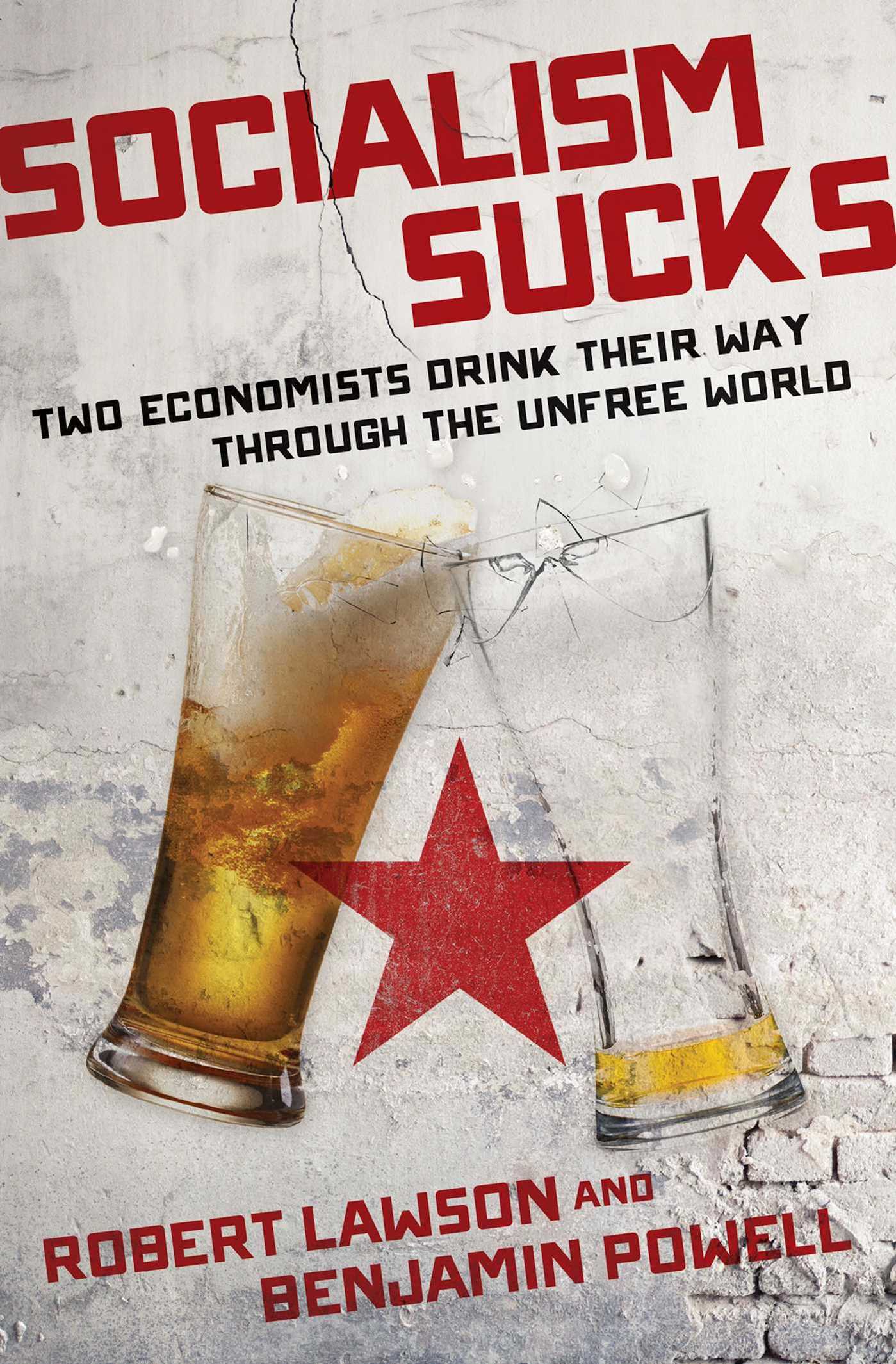
Socialism Sucks The bastard step-child of Milton Friedman and Anthony Bourdain, Socialism Sucks is a bar-crawl through former, current, and wannabe socialist countries around the world. Free market economists Robert Lawson and Benjamin Powell travel to countries like Venezuela, Cuba, Russia, and Sweden to investigate the dangers and idiocies of socialism—while drinking a lot of beer. POLITICAL SCIENCE,Political Ideologies,Communism,Post-Communism & Socialism
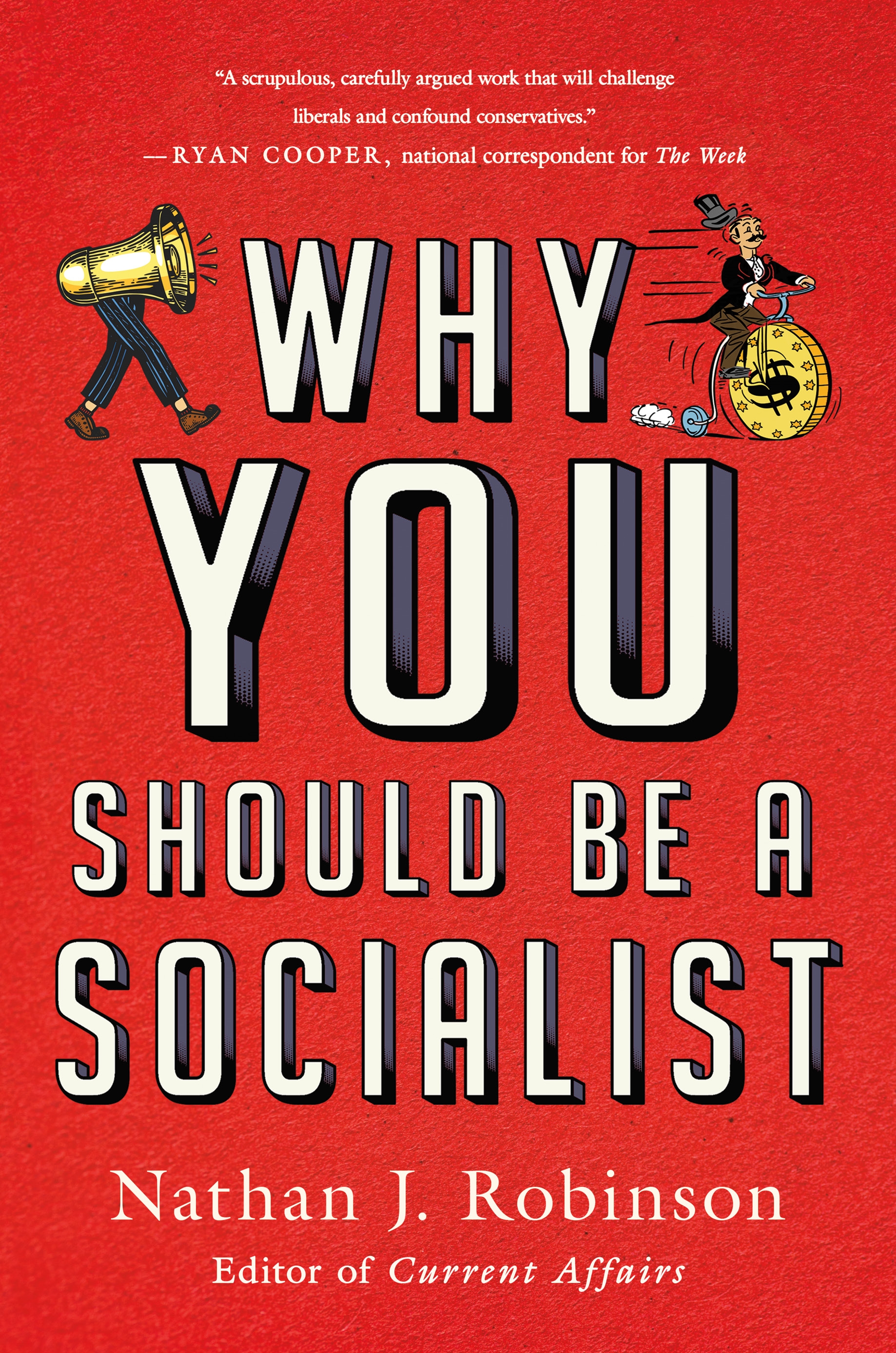
Why You Should Be a Socialist A primer on Democratic Socialism for those who are extremely skeptical of it. America is witnessing the rise of a new generation of socialist activists. More young people support socialism now than at any time since the labor movement of the 1920s. The Democratic Socialists of America, a big-tent leftist organization, has just surpassed 50,000 members nationwide. In the fall of 2018, one of the most influential congressmen in the Democratic Party lost a primary to Alexandria Ocasio-Cortez, a 28-year-old socialist who had never held office before. But what does all this mean? Should we be worried about our country, or should we join the march toward our bright socialist future? In Why You Should Be a Socialist, Nathan J. Robinson will give readers a primer on twenty-first-century socialism: what it is, what it isn’t, and why everyone should want to be a part of this exciting new chapter of American politics. From the heyday of Occupy Wall Street through Bernie Sanders’ 2016 presidential campaign and beyond, young progressives have been increasingly drawn to socialist ideas. However, the movement’s goals need to be defined more sharply before it can effect real change on a national scale. Likewise, liberals and conservatives will benefit from a deeper understanding of the true nature of this ideology, whether they agree with it or not. Robinson’s charming, accessible, and well-argued book will convince even the most skeptical readers of the merits of socialist thought. POLITICAL SCIENCE,Political Ideologies,Communism,Post-Communism & Socialism
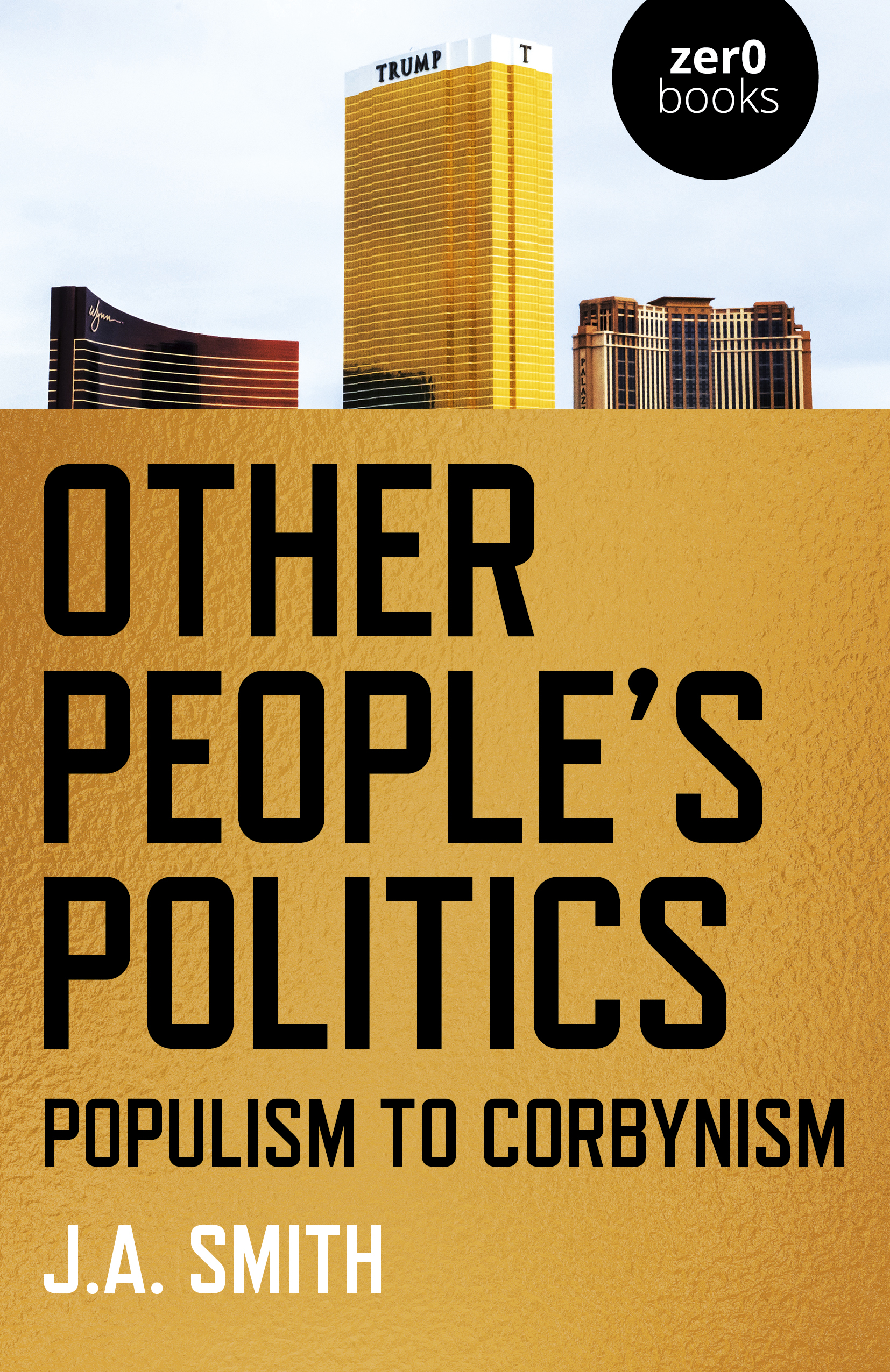
Other People's Politics From right to left: the indispensable guide to post-2016 life, under Populism, Corbynism... and after. POLITICAL SCIENCE,Political Ideologies,Communism,Post-Communism & Socialism
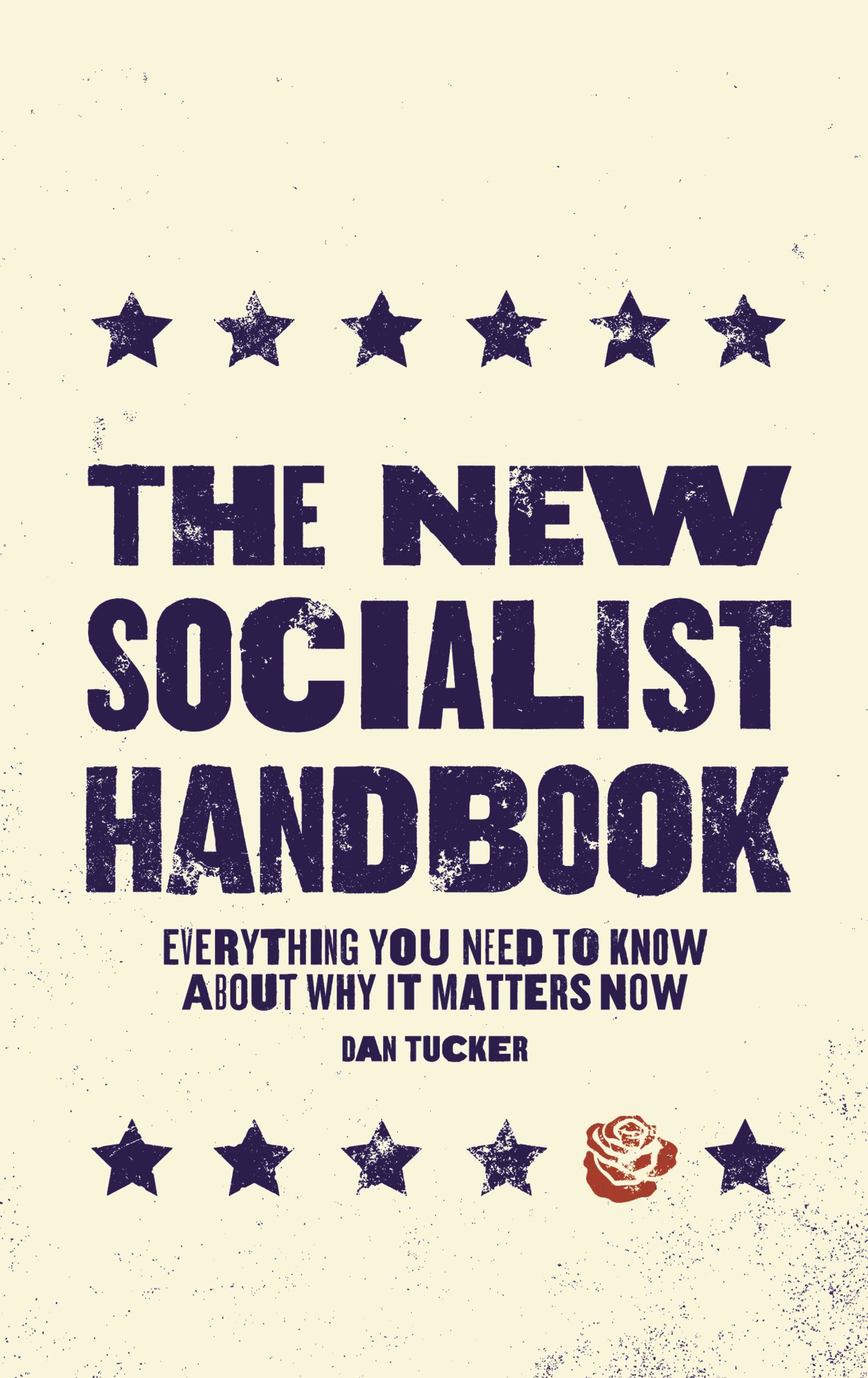
The New Socialist Handbook Learn the core principles of socialism -- one of the world's most misunderstood ideologies -- with this easy-to-follow guide for today's political conversation. From Bernie Sanders' presidential campaign to Alexandria Ocasio-Cortez's Green New Deal, the U.S. is witnessing a leftward shift that hasn't been seen for decades. But how many Americans truly understand socialism and socialist principles? The New Socialist Handbook is a simple way to learn about this political system and bear witness to its current movement with an educated and informed mind. It discusses topics such as: Different types of socialism (democratic socialism vs. social democracy vs. eco-socialism, etc.); How socialism became a dirty word; Which countries are socialist or have socialist programs; The way socialism exists in the U.S. today (Medicare, Social Security, etc.); Socialist suggestions for today's issues (healthcare, infrastructure, economy, etc.); What can you do to bring about change? (getting involved in politics, educating yourself, demonstrating, etc.) Perfect for the engaged voter or the armchair political scientist, pundit, enthusiast, or anyone simply looking to get a better intellectual grasp on socialism, The New Socialist Handbook gives meaning and definition to the commonly misunderstood. Author Dan Tucker breaks down these topics in a clear, accessible way and without a political slant. Readers will come away with a better understanding of the history of socialism and what it means in our world today. POLITICAL SCIENCE,Political Ideologies,Communism,Post-Communism & Socialism
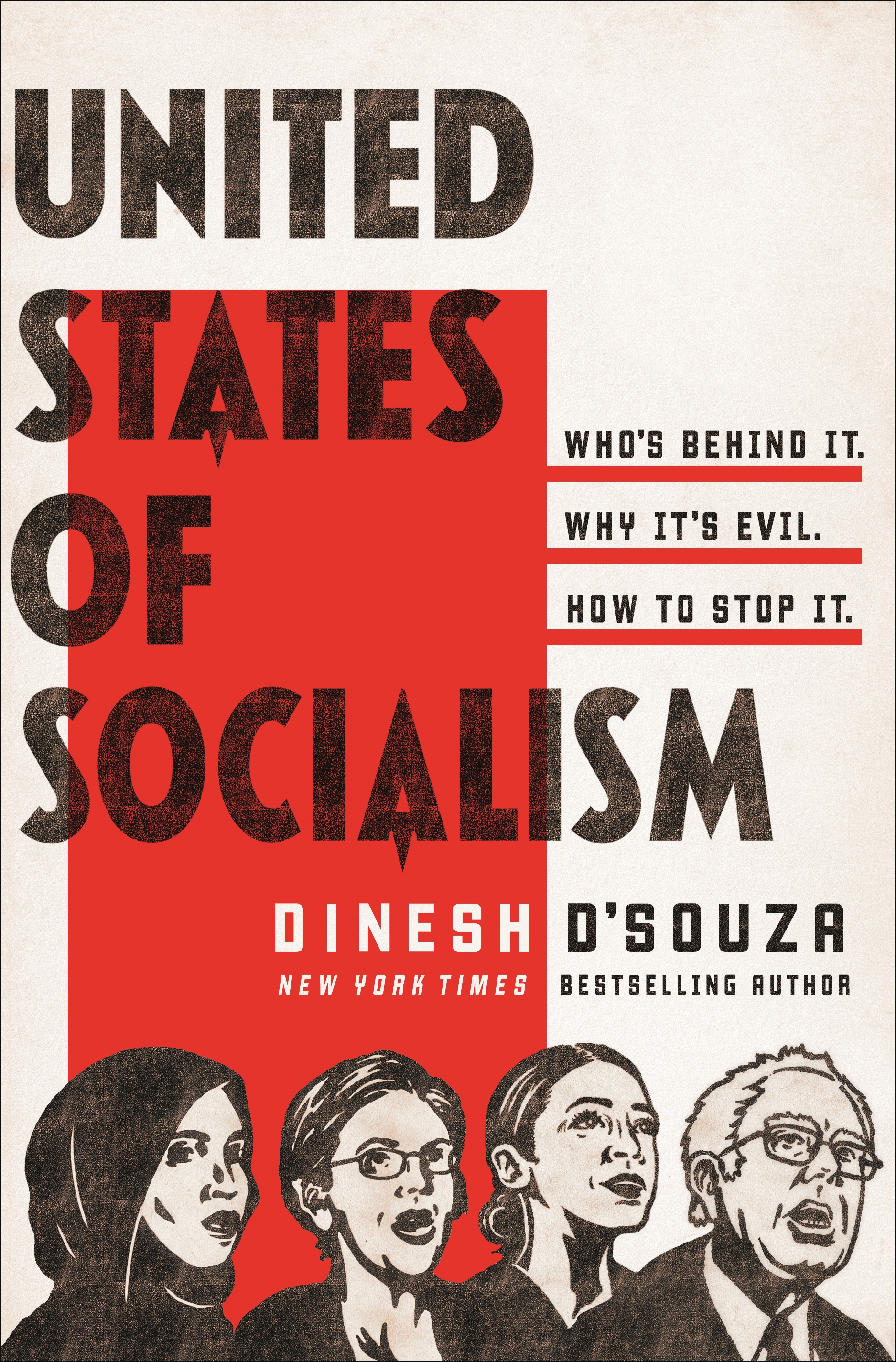
United States of Socialism The New York Times, USA Today, Publishers Weekly, and Wall Street Journal Bestseller For those who witnessed the global collapse of socialism, its resurrection in the twenty-first century comes as a surprise, even a shock. How can socialism work now when it has never worked before? In this pathbreaking book, bestselling author Dinesh D’Souza argues that the socialism advanced today by the likes of Alexandria Ocasio-Cortez, Bernie Sanders, Ilhan Omar and Elizabeth Warren is very different from the socialism of Lenin, Mao and Castro. It is “identity socialism,†a marriage between classic socialism and identity politics. Today’s socialists claim to model themselves not on Mao’s Great Leap Forward or even Venezuelan socialism but rather on the “socialism that works†in Scandinavian countries like Norway and Sweden. This is the new face of socialism that D’Souza confronts and decisively refutes with his trademark incisiveness, wit and originality. He shows how socialism abandoned the working class and found new recruits by drawing on the resentments of race, gender and sexual orientation. He reveals how it uses the Venezuelan, not the Scandinavian, formula. D’Souza chillingly documents the full range of lawless, gangster, and authoritarian tendencies that they have adopted. United States of Socialism is an informative, provocative and thrilling exposé not merely of the ideas but also the tactics of the socialist Left. In making the moral case for entrepreneurs and the free market, the author portrays President Trump as the exemplar of capitalism and also the most effective political leader of the battle against socialism. He shows how we can help Trump defeat the socialist menace. POLITICAL SCIENCE,Political Ideologies,Communism,Post-Communism & Socialism
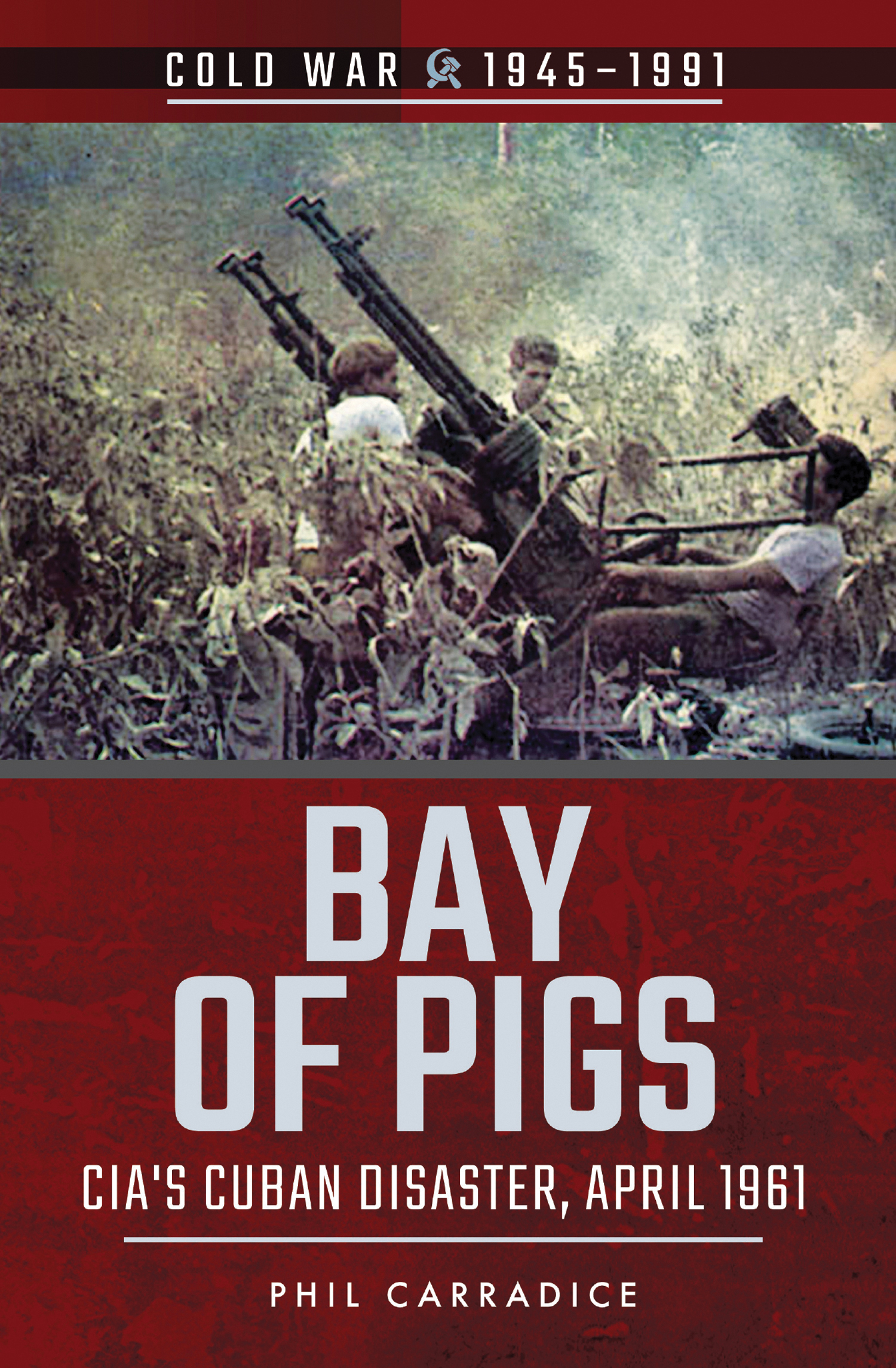
Bay of Pigs Perhaps not in casualties but as far as prestige and standing in the world were concerned, the Bay of Pigs invasion of 1961 was the worst disaster to befall the USA since the War of 1812 when British forces burned the White House. Badly planned, badly organized, the affair was littered with mistakes from start to finish not least with an inept performance by John F Kennedy and his new administration.Supposedly an attempt by Cuban exiles to regain their homeland, the whole operation was funded and equipped by the USA. When things began to go wrong with the landings at Playa Larga and Playa Giron on the southern coast of Cuba President Kennedy and his advisers began overruling military decisions with the result that the invading Brigade 2506 made up of Cuban exiles was left with little or no air cover, limited ammunition and no easy escape.Fidel Castro made great play of his success and American failure at the Bay of Pigs. He, like Nikita Khrushchev, thought Kennedy was weak: the Cuban Missile Crisis of the following year was almost an inevitable consequence of the disaster. POLITICAL SCIENCE,Political Ideologies,Communism,Post-Communism & Socialism

Socialism . . . Seriously “Katch has done the impossible: he makes socialism sexy . . . eye-opening, inspiring, and funny . . . this book might turn you into a closet socialist†(Judah Friedlander, actor and comedian). Opinion polls show that many people in the United States prefer socialism to capitalism. But after being declared dead and buried for decades, socialism has come to mean little more than something vaguely less cruel and stupid than what we have now. That’s not exactly going to inspire millions to storm the barricades. Danny Katch brings together the two great Marxist traditions of Karl and Groucho to provide an entertaining and insightful introduction to what the socialist tradition has to say about democracy, economics, and the potential of human beings to be something more than being bomb-dropping, planet-destroying racist fools. “The most hilarious book about socialism since Karl Marx and his brother Harpo wrote their joke book.†—Hari Kondabolu, filmmaker and comedian “If The Communist Manifesto and America’s Funniest Home Videos had a baby, it would be Danny Katch’s new book. It’s a hilarious and fun way to think about what’s wrong with our world, how it could be different, and how we might get there. Keep an extra copy of Socialism . . . Seriously in your bag and hand it to the next person who asks you what socialism is all about; as long as that person is not your boss . . . seriously.†—Brian Jones, actor, educator, and activist “A lighthearted, easy read that packs an intro course on socialism into a short volume. With jokes that made me laugh out loud, and a lot of heart. Socialism is for lovers. Indeed.†—Sarah Jaffe, Belabored podcast host POLITICAL SCIENCE,Political Ideologies,Communism,Post-Communism & Socialism
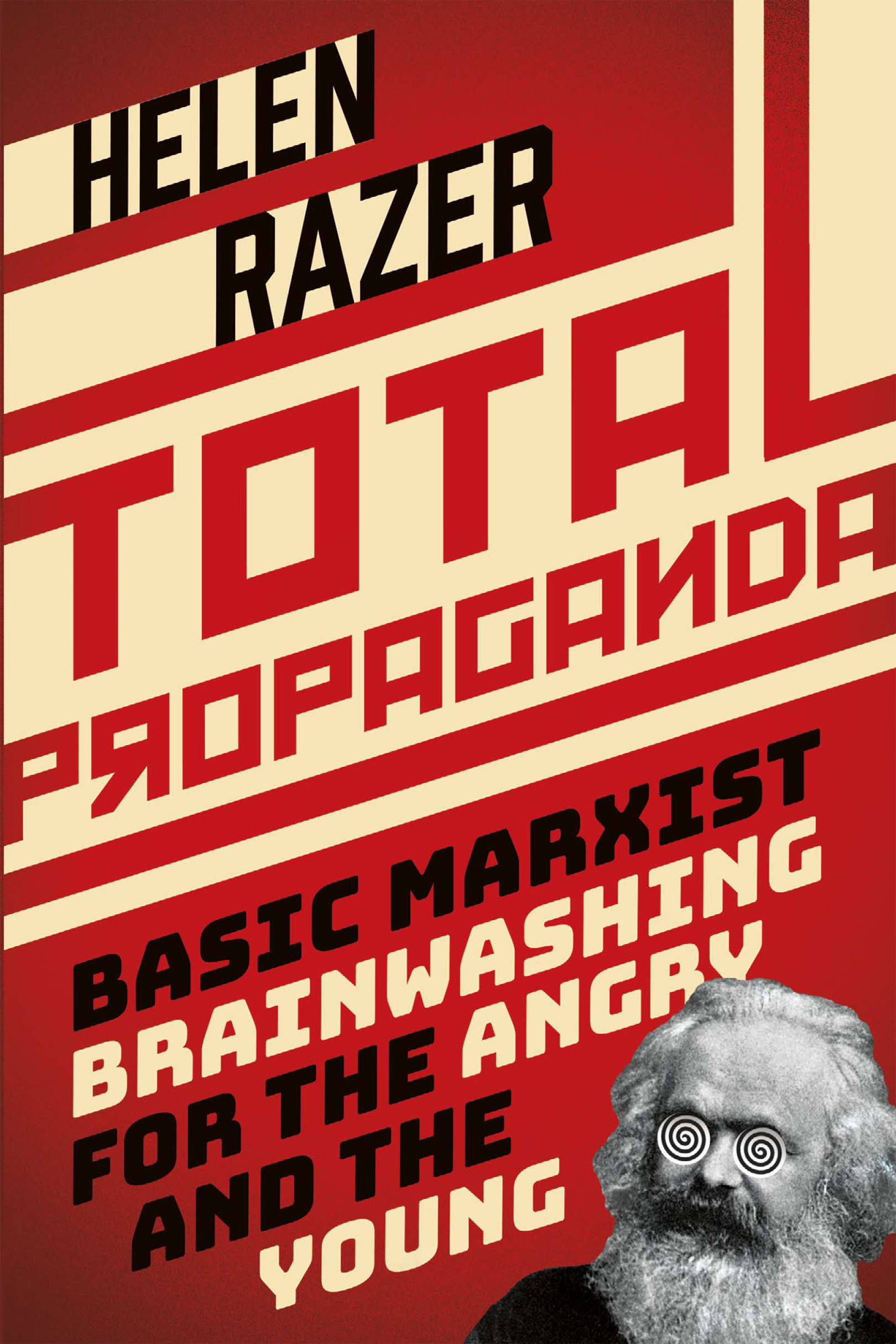
Total Propaganda Pushy old communist Helen Razer offers an introduction to the thought of Marx for Millennials and anyone else tired of wage stagnation, growing global poverty, and economists writing desperate columns saying everything would work better, if only we stopped eating sandwiches. POLITICAL SCIENCE,Political Ideologies,Communism,Post-Communism & Socialism
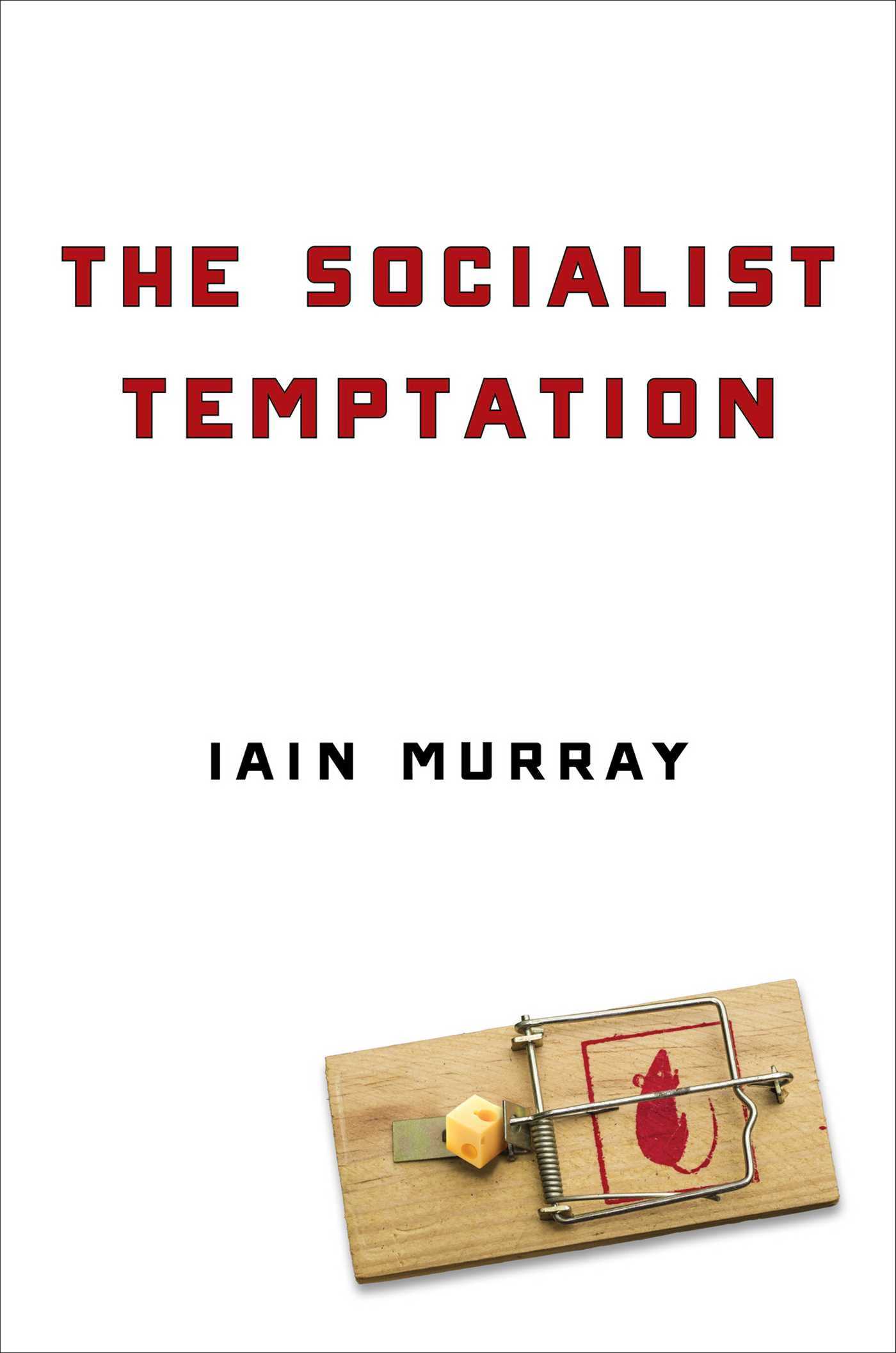
The Socialist Temptation Socialism is tempting, seductive, alluring. It comes in many forms and speaks in many different ways. It appeals to people who value fairness, who value freedom, and who value security. It comes in many varieties, sometimes clothing itself in the dress of nationalism, sometimes in the garb of environmentalism. Yet there is one single, unifying feature – subjugation of the individual to the collective. While Americans have always been skeptical of socialism, even in the progressive and New Deal eras, that is beginning to change. Large numbers of Americans now express admiration for socialism, and similar numbers are critical of the free enterprise system. The problem is particularly acute among America’s young people. This is not the first time we have been here. In 1977, when America was deep in an economic malaise, Ronald Reagan gave a speech in which he wondered, “Whatever happened to free enterprise?†Noting that the free enterprise system “for 200 years made us the light of the world,†he warned that freedom is “never more than one generation away from extinction.†He took the lead in preserving it for the previous generation. It is time for this generation to take up the torch. Reagan framed the defense of freedom as first and foremost a communications challenge. Today, a field of study known as cultural cognition theory understands that our political choices are guided by certain values. Americans generally fall into one of three value groups, valuing fairness (egalitarians), freedom (libertarians), and security (conservatives) respectively. The Socialist Temptation is an attempt to meet the modern version of the communications challenge posed by Ronald Reagan. There are reasons why socialism appeals to each of these value groups. The Socialist Temptation tackles these reasons head on and responds with a vigorous case for free enterprise as better matching American values. POLITICAL SCIENCE,Political Ideologies,Communism,Post-Communism & Socialism

Bowling for Communism Bowling for Communism illuminates how civic life functioned in Leipzig, East Germany's second-largest city, on the eve of the 1989 revolution by exploring acts of "urban ingenuity" amid catastrophic urban decay. Andrew Demshuk profiles the creative activism of local communist officials who, with the help of scores of volunteers, constructed a palatial bowling alley without Berlin's knowledge or approval. In a city mired in disrepair, civic pride overcame resentment against a regime loathed for corruption, Stasi spies, and the Berlin Wall. Reconstructing such episodes through interviews and obscure archival materials, Demshuk shows how the public sphere functioned in Leipzig before the fall of communism. Hardly detached or inept, local officials worked around centralized failings to build a more humane city. And hardly disengaged, residents turned to black-market construction to patch up their surroundings. Because such "urban ingenuity" was premised on weakness in the centralized regime, the dystopian cityscape evolved from being merely a quotidian grievance to the backdrop for revolution. If, by their actions, officials were demonstrating that the regime was irrelevant, and if, in their own experiences, locals only attained basic repairs outside official channels, why should anyone have mourned the system when it was overthrown? POLITICAL SCIENCE,Political Ideologies,Communism,Post-Communism & Socialism
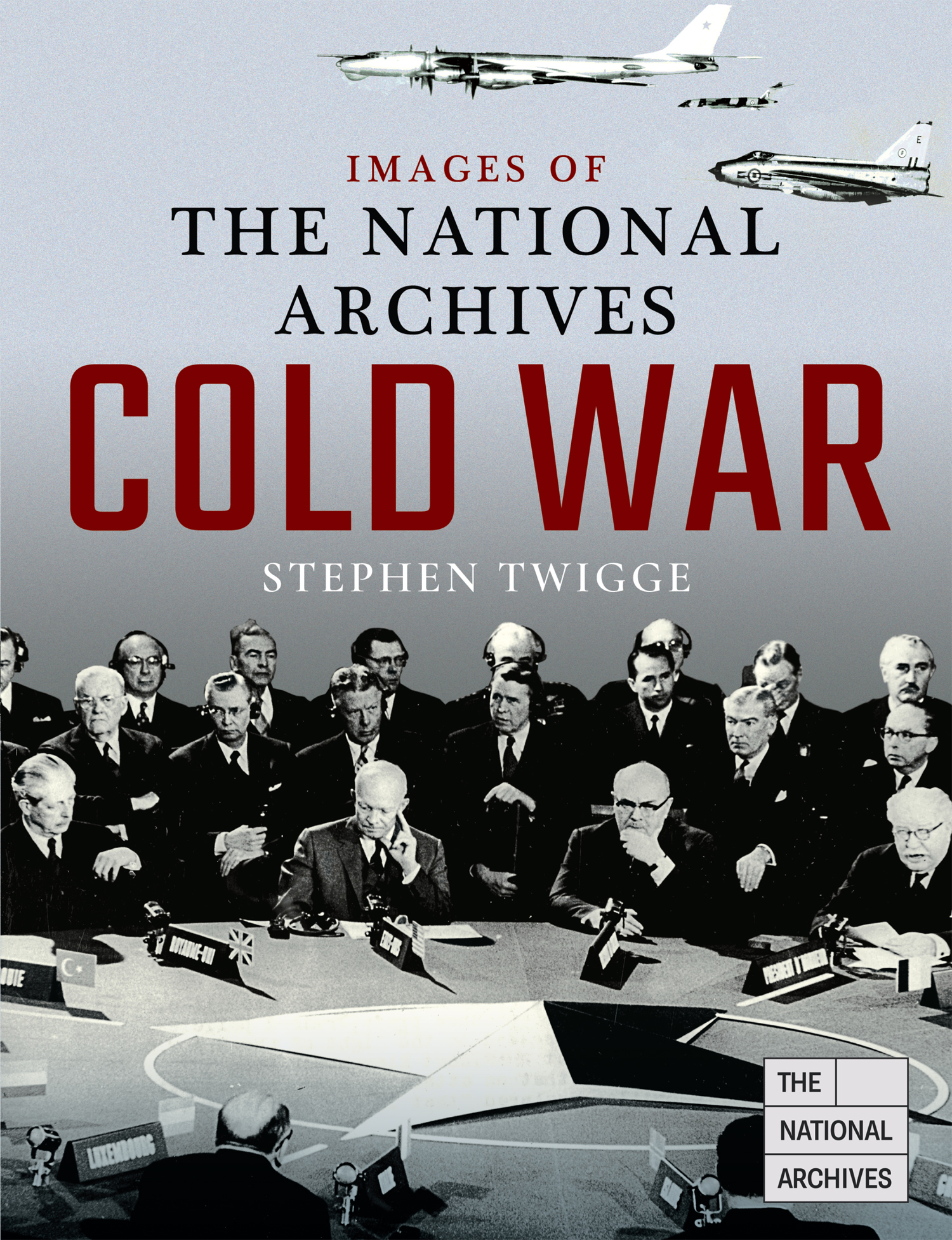
Cold War Cold War tells the story of half a century of superpower confrontation from the end of the Second World War to the collapse of the Soviet Union. The book describes in chilling detail the military and ideological struggle between the United States and the Soviet Union that dominated the postwar landscape. The book highlights the role played by Britain during the Cold War and its involvement in Cold War flash points including the Berlin Blockade, the Cuban Missile Crisis and the Soviet invasion of Afghanistan. The book describes the devastating consequences of nuclear war, the growth and influence of the peace movement and the exploits of the Cold War spy networks built up by both sides. Based on previously secret government reports and papers, the book tells a compelling story of global conflict and superpower politics set against a backdrop of dramatic social and cultural change. POLITICAL SCIENCE,Political Ideologies,Communism,Post-Communism & Socialism

On Hitler's Mein Kampf An examination of the narrative strategies employed in the most dangerous book of the twentieth century and a reflection on totalitarian literature. Hitler's Mein Kampf was banned in Germany for almost seventy years, kept from being reprinted by the accidental copyright holder, the Bavarian Ministry of Finance. In December 2015, the first German edition of Mein Kampf since 1946 appeared, with Hitler's text surrounded by scholarly commentary apparently meant to act as a kind of cordon sanitaire. And yet the dominant critical assessment (in Germany and elsewhere) of the most dangerous book of the twentieth century is that it is boring, unoriginal, jargon-laden, badly written, embarrassingly rabid, and altogether ludicrous. (Even in the 1920s, the consensus was that the author of such a book had no future in politics.) How did the unreadable Mein Kampf manage to become so historically significant? In this book, German literary scholar Albrecht Koschorke attempts to explain the power of Hitler's book by examining its narrative strategies. Koschorke argues that Mein Kampf cannot be reduced to an ideological message directed to all readers. By examining the text and the signals that it sends, he shows that we can discover for whom Hitler strikes his propagandistic poses and who is excluded. Koschorke parses the borrowings from the right-wing press, the autobiographical details concocted to make political points, the attack on the Social Democrats that bleeds into an anti-Semitic conspiracy theory, the contempt for science, and the conscious attempt to trigger outrage. A close reading of National Socialism's definitive text, Koschorke concludes, can shed light on the dynamics of fanaticism. This lesson of Mein Kampf still needs to be learned. POLITICAL SCIENCE,Political Ideologies,Communism,Post-Communism & Socialism
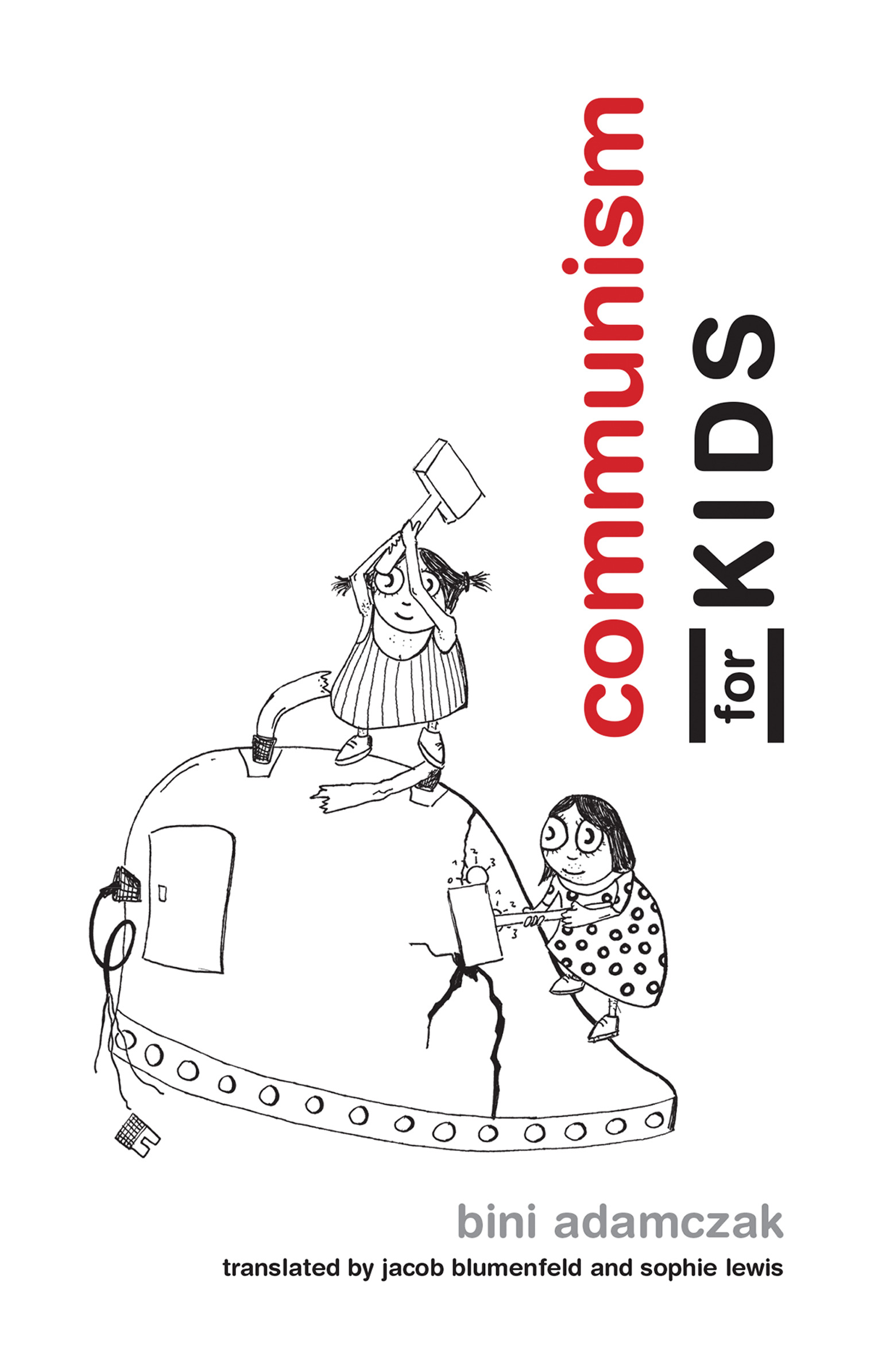
Communism for Kids Communism, capitalism, work, crisis, and the market, described in simple storybook terms and illustrated by drawings of adorable little revolutionaries. Once upon a time, people yearned to be free of the misery of capitalism. How could their dreams come true? This little book proposes a different kind of communism, one that is true to its ideals and free from authoritarianism. Offering relief for many who have been numbed by Marxist exegesis and given headaches by the earnest pompousness of socialist politics, it presents political theory in the simple terms of a children's story, accompanied by illustrations of lovable little revolutionaries experiencing their political awakening. It all unfolds like a story, with jealous princesses, fancy swords, displaced peasants, mean bosses, and tired workers–not to mention a Ouija board, a talking chair, and a big pot called “the state.” Before they know it, readers are learning about the economic history of feudalism, class struggles in capitalism, different ideas of communism, and more. Finally, competition between two factories leads to a crisis that the workers attempt to solve in six different ways (most of them borrowed from historic models of communist or socialist change). Each attempt fails, since true communism is not so easy after all. But it's also not that hard. At last, the people take everything into their own hands and decide for themselves how to continue. Happy ending? Only the future will tell. With an epilogue that goes deeper into the theoretical issues behind the story, this book is perfect for all ages and all who desire a better world. POLITICAL SCIENCE,Political Ideologies,Communism,Post-Communism & Socialism
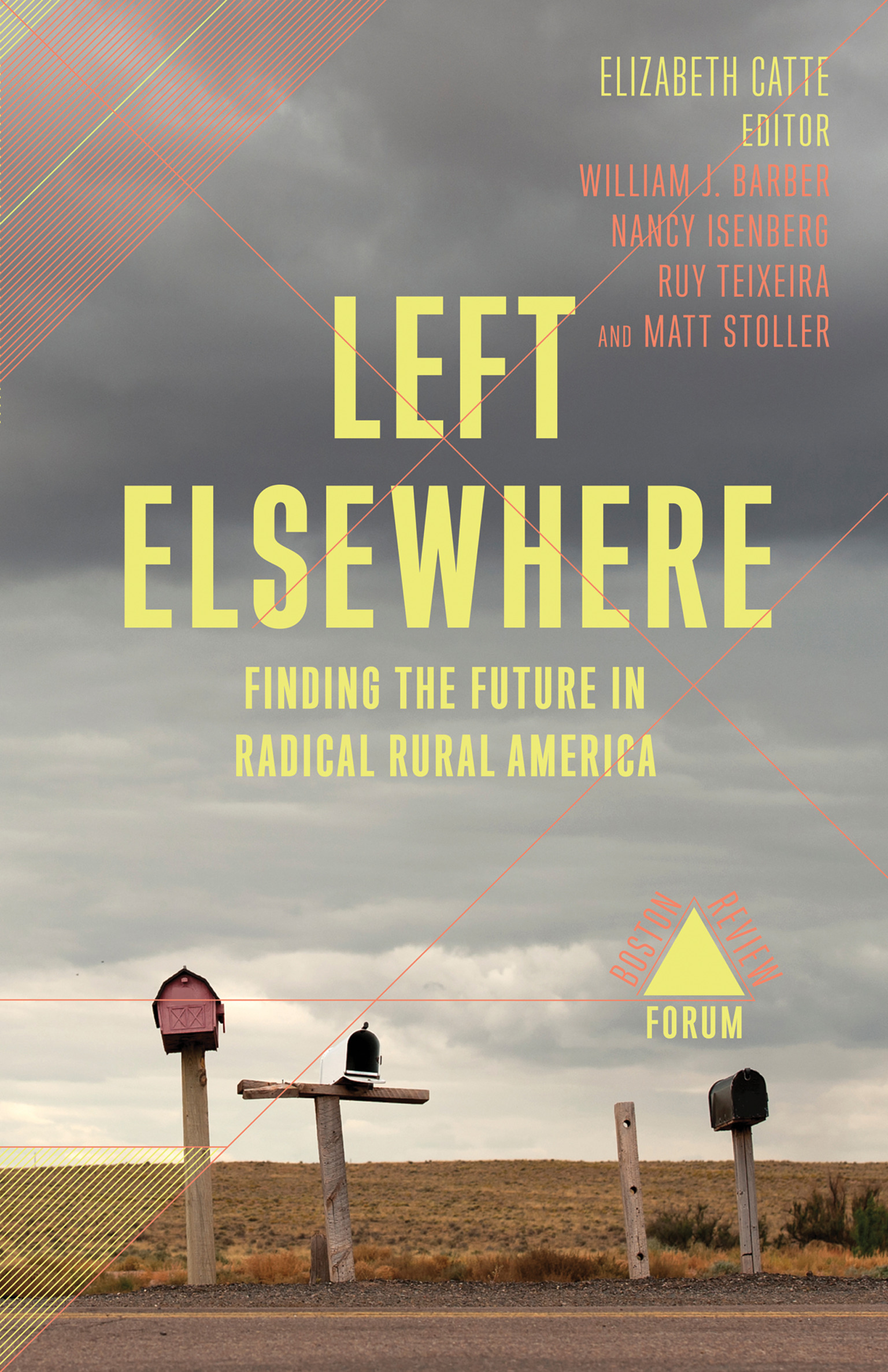
Left Elsewhere An examination of the emerging rural left, from environmentalists blocking pipeline construction to teachers on strike. In Left Elsewhere, volume editor and lead essayist Elizabeth Catte turns a skeptical eye toward “purple” politicians, such as West Virginia Democrat Richard Ojeda, who are hailed by many as the best hope for U.S. progressives outside the urban coasts. By offering a survey of what the left actually looks like outside major urban centers, Catte shows how an emerging rural left is developing new strategies that do not easily fit into typical ideas of liberals, leftists, and Democratic politics. From environmentalists who successfully block pipeline construction to advocates for “radical” health care solutions such as needle exchanges to school teachers who go on strike, these newly energized activists may offer a better path forward for both policy and candidates to represent the needs of poor and working Americans. By engaging activists and scholars outside the coastal bubbles, this collection offers insights into several overlooked areas, including working-class women's activism, victories in new labor struggle (especially in staunchly right-to-work states) and new organizing principles in Jackson, Mississippi—"America's most radical city"—that are bringing about meaningful racial and economic change on the ground. Taken together, the essays in Left Elsewhere show that today's political language is insufficient to convey what's happening in these areas and examine what, if any, coherent set of politics can be assigned to them. Contributors William J. Barber II, Thomas Baxter, Lesly-Marie Buer, Ash-Lee Woodard Henderson, Nancy Isenberg, Elaine C. Kamarck, Michael Kazin, Toussaint Losier, Robin McDowell, Bob Moser, Hugh Ryan, Matt Stoller, Ruy Teixeira, Makani Themba, Jessica Wilkerson POLITICAL SCIENCE,Political Ideologies,Communism,Post-Communism & Socialism
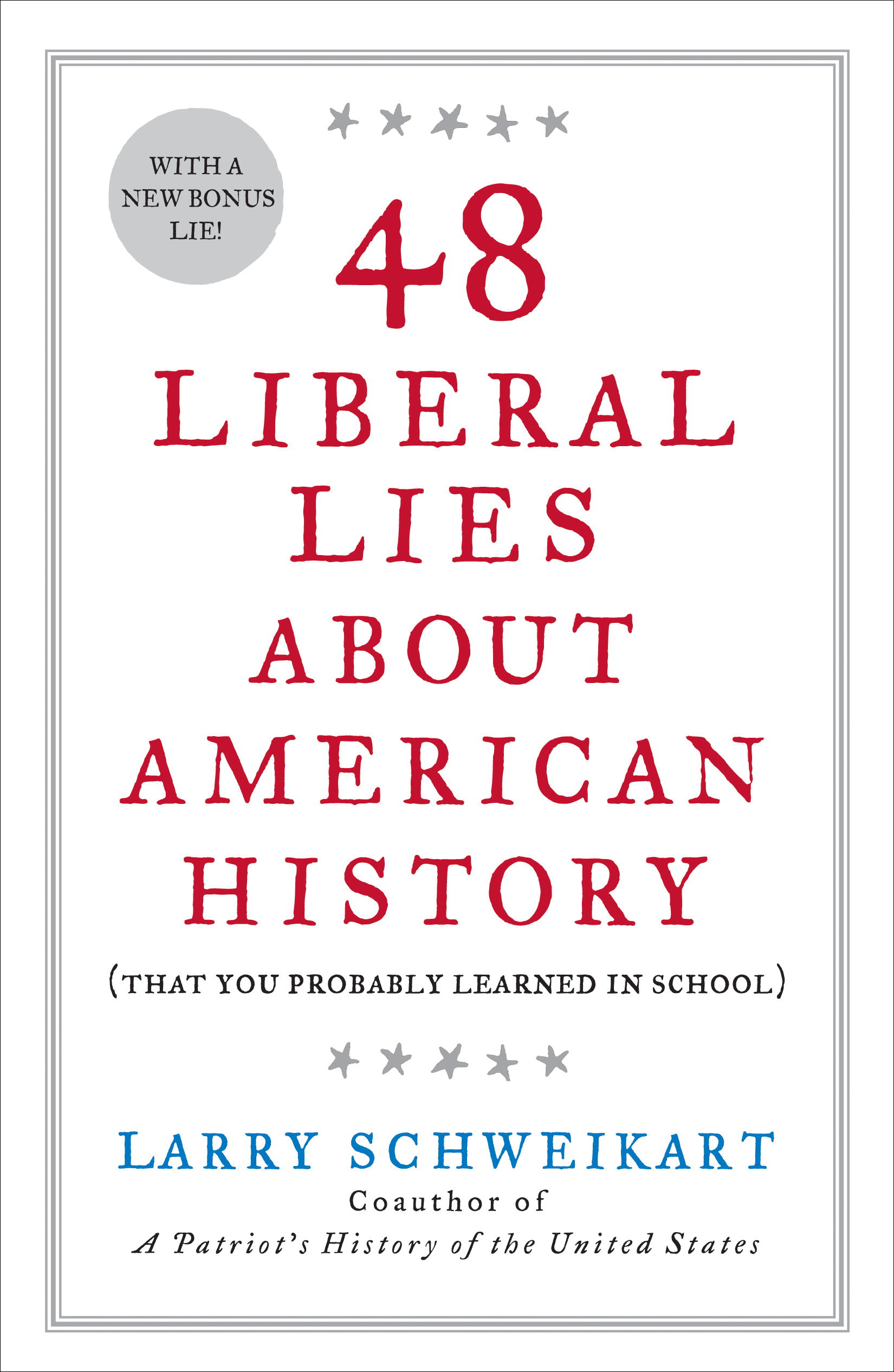
48 Liberal Lies About American History A historian debunks four-dozen PC myths about our nation's past. Over the last forty years, history textbooks have become more and more politically correct and distorted about our country's past, argues professor Larry Schweikart. The result, he says, is that students graduate from high school and even college with twisted beliefs about economics, foreign policy, war, religion, race relations, and many other subjects. As he did in his popular A Patriot's History of the United States, Professor Schweikart corrects liberal bias by rediscovering facts that were once widely known. He challenges distorted books by name and debunks forty-eight common myths. A sample: • The founders wanted to create a wall of separation between church and state • Lincoln issued the Emancipation Proclamation only because he needed black soldiers • Truman ordered the bombing of Hiroshima to intimidate the Soviets with atomic diplomacy • Mikhail Gorbachev, not Ronald Reagan, was responsible for ending the Cold War America's past, though not perfect, is far more admirable than you were probably taught. POLITICAL SCIENCE,Political Ideologies,Conservatism & Liberalism
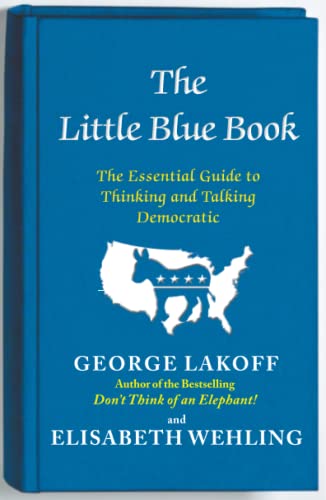
The Little Blue Book The indispensable handbook for Democrats Voters cast their ballots for what they believe is right, for the things that make moral sense. Yet Democrats have too often failed to use language linking their moral values with their policies. The Little Blue Book demonstrates how to make that connection clearly and forcefully, with hands-on advice for discussing the most pressing issues of our time: the economy, health care, women’s issues, energy and environmental policy, education, food policy, and more. Dissecting the ways that extreme conservative positions have permeated political discourse, Lakoff and Wehling show how to fight back on moral grounds and in concrete terms. Revelatory, passionate, and deeply practical, The Little Blue Book will forever alter the way Democrats and progressives think and talk about politics. POLITICAL SCIENCE,Political Ideologies,Conservatism & Liberalism
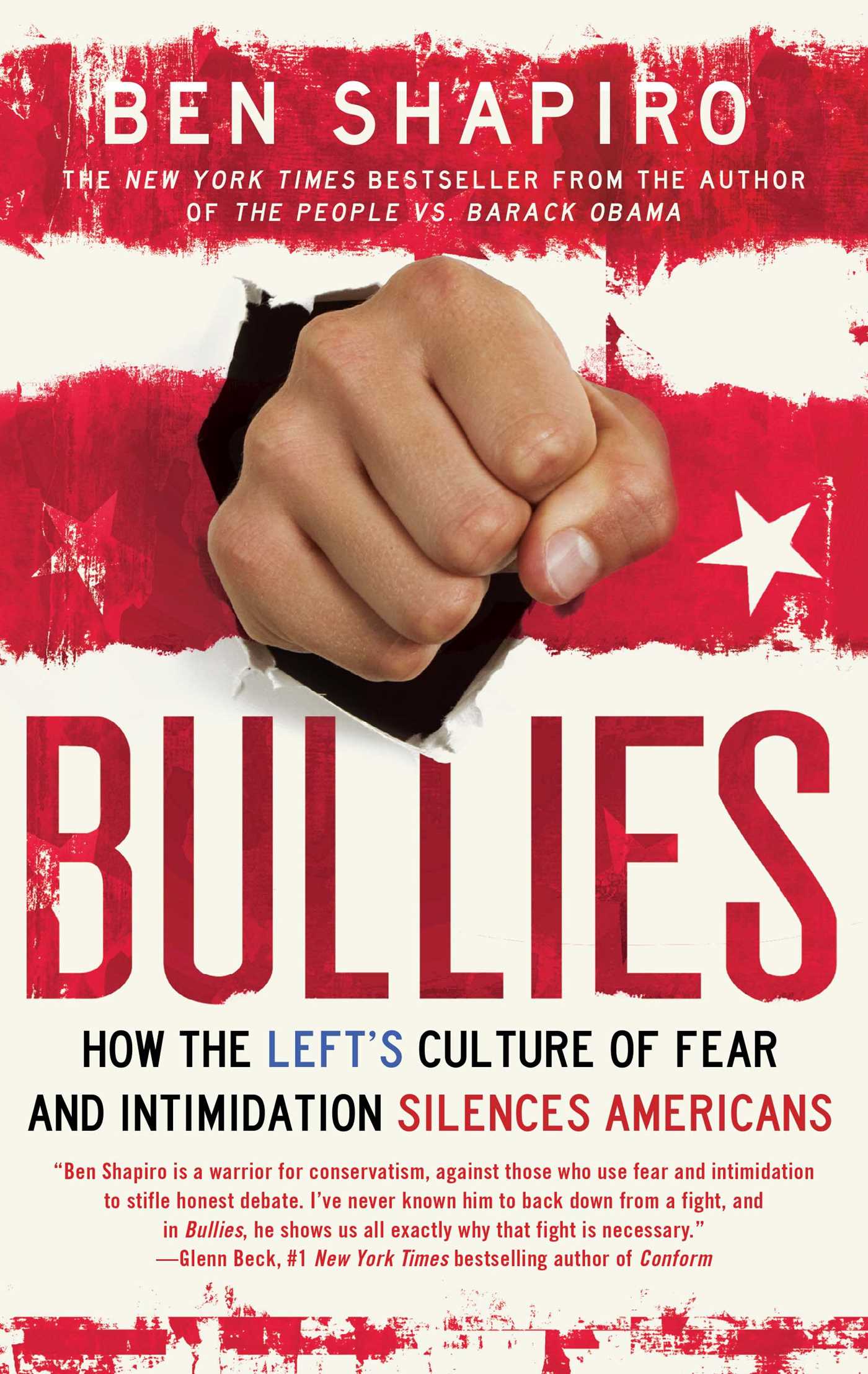
Bullies From the editor-at-large of Breitbart.com comes a galvanizing and alarming look at the strategy and tactics of leftist thuggery. While President Obama and the left like to pretend that they oppose bullying with all their hearts and souls, the truth is far darker: the left is the greatest purveyor of bullying in modern American history. Bullying has morphed into the left’s go-to tactic, as they attempt to quash their opponents through fear, threat of force, violence, and rhetorical intimidation on every major issue facing America today. Ben Shapiro uncovers the simple strategy used by liberals and their friends in the media: bully the living hell out of conservatives. Play the race card, the class card, the sexism card. Use any and every means at your disposal to demonize your opposition—to shut them up. Then pretend that such bullying is justified, because, after all, conservatives are the true bullies, and need to be taught a lesson for their intolerance. Hidden beneath the left’s supposed hatred of bullying lies a passionate love of its vulgar tactics. The left has created a climate of fear wherein ordinary Americans must abandon their principles, back abhorrent causes, and remain silent. They believe America is a force for evil, that our military is composed of war criminals, and that patriotism is the deepest form of treason. They incite riots and threaten violence by playing the race card, then claim they’re advocates for tolerance. Disagree with Obama? You must be a racist. They send out union thugs and Occupy Wall Street anarchists to destroy businesses and redistribute the wealth of earners and job creators. No target is off limits as liberal feminists declare war against stay-at-home moms, and gay activists out their enemies, destroy careers, and desecrate personal privacy. These are the most despicable people in America, bullying their opponents while claiming to be the victims. Shapiro takes on the leftist bullies, exposes their hypocrisy, and offers conservatives a reality check in the face of what has become the gravest threat to American liberty: the left’s single-minded focus on ending political debate through bully tactics. POLITICAL SCIENCE,Political Ideologies,Conservatism & Liberalism
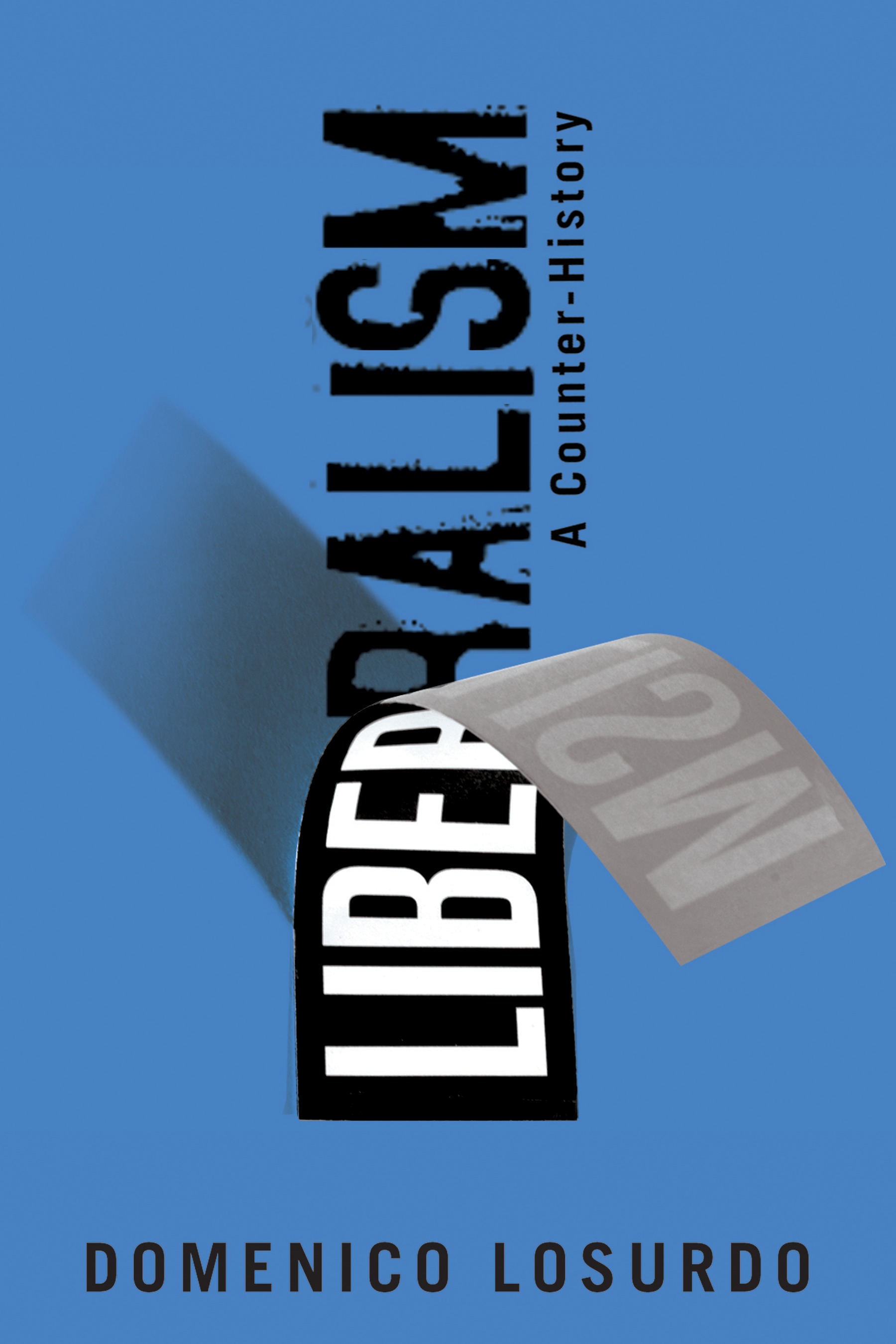
Liberalism In this definitive historical investigation, Italian author and philosopher Domenico Losurdo argues that from the outset liberalism, as a philosophical position and ideology, has been bound up with the most illiberal of policies: slavery, colonialism, genocide, racism and snobbery. Narrating an intellectual history running from the eighteenth through to the twentieth centuries, Losurdo examines the thought of preeminent liberal writers such as Locke, Burke, Tocqueville, Constant, Bentham, and Sieyès, revealing the inner contradictions of an intellectual position that has exercised a formative influence on today’s politics. Among the dominant strains of liberalism, he discerns the counter-currents of more radical positions, lost in the constitution of the modern world order. POLITICAL SCIENCE,Political Ideologies,Conservatism & Liberalism
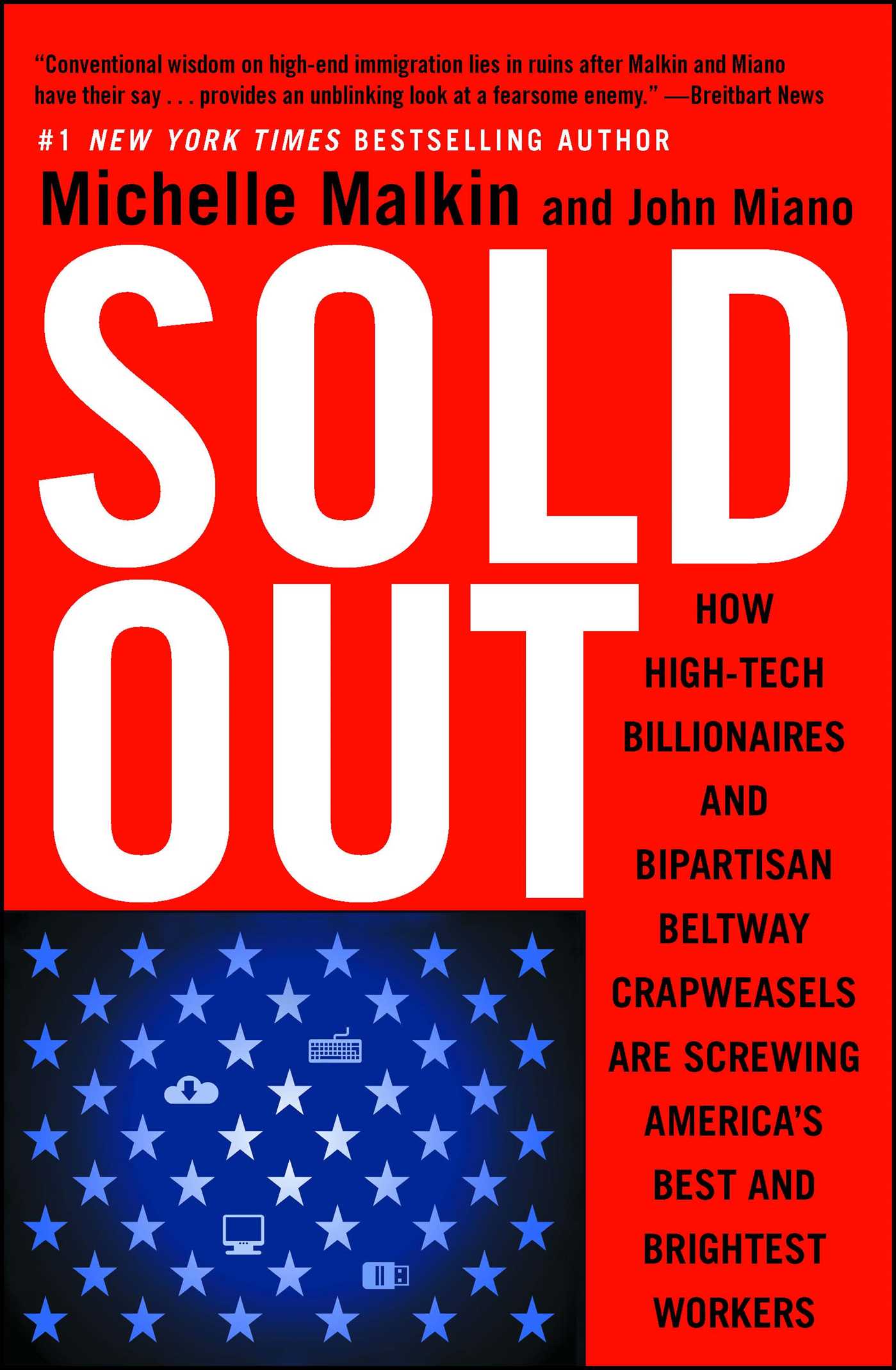
Sold Out The #1 New York Times bestselling author and firebrand syndicated columnist Michelle Malkin sets her sights on the corrupt businessmen, politicians, and lobbyists flooding our borders and selling out America’s best and brightest workers. In Sold Out, Michelle Malkin and John Miano name names and expose the lies of those who pretend to champion the middle class, while aiding and abetting massive layoffs of highly skilled American workers in favor of cheap foreign labor. Malkin and Miano will explode some of the most commonly told myths spread in the media like these: Lie #1: America is suffering from an apocalyptic “shortage†of science, technology, engineering, and math workers. Lie #2: US companies cannot function without an unlimited injection of the “highly skilled†and “highly educated†foreign workers, who offer capital and energy that American workers can’t match. Lie #3: America’s best and brightest talents are protected because employers are required to demonstrate that they’ve made every effort to hire American citizens before resorting to foreign labor. For too long, open-borders tech billionaires and their political enablers have escaped tough public scrutiny of their means and motives. It’s time to trade the whitewash for solvent. American workers deserve better and the public deserves the unvarnished truth. POLITICAL SCIENCE,Political Ideologies,Conservatism & Liberalism
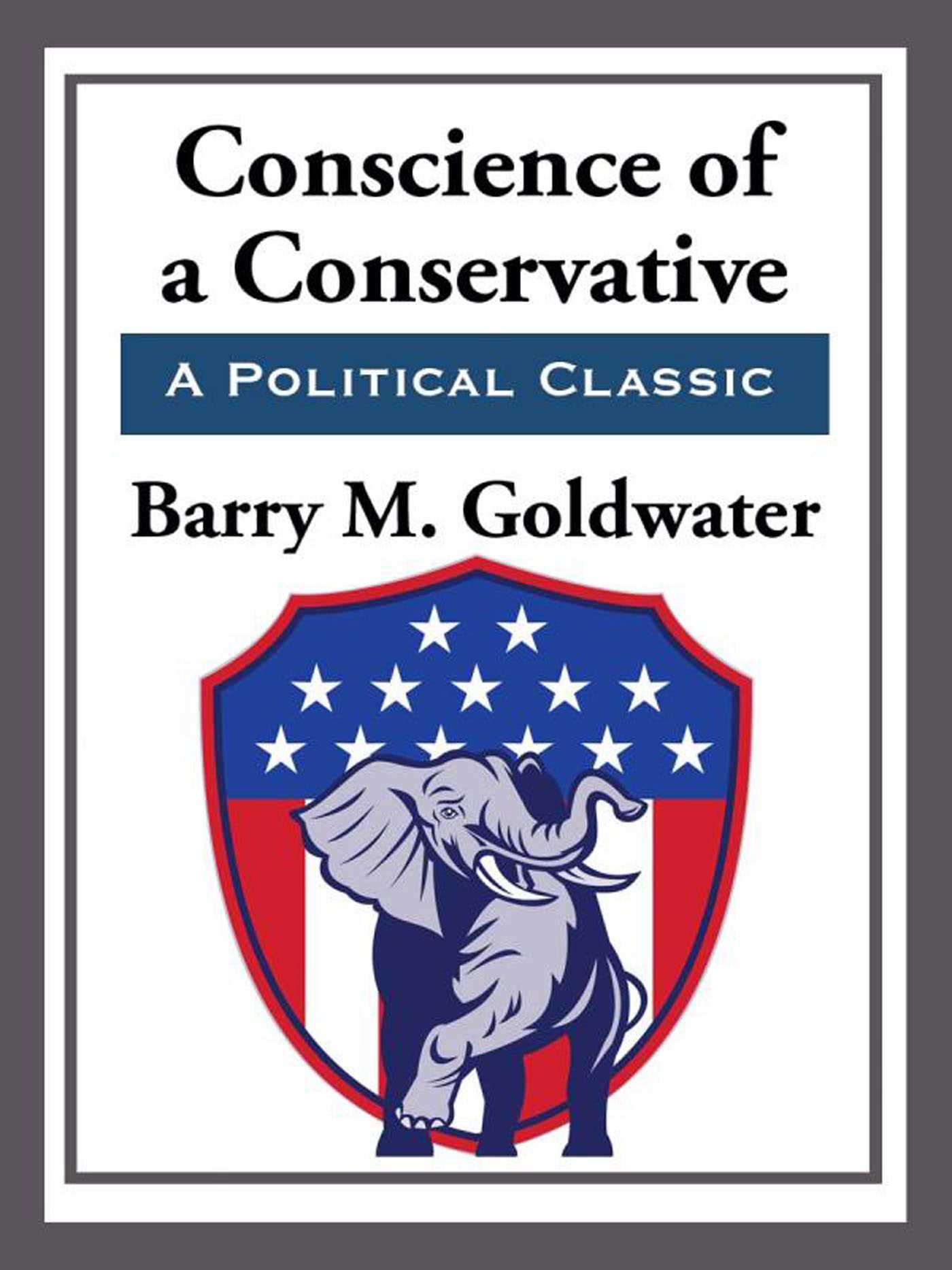
Conscience of a Conservative The Conscience of a Conservative reignited the American conservative movement and made Barry Goldwater a political star. It influenced countless conservatives in the United States, and helped lay the foundation for the Reagan Revolution in 1980. It covers topics such as education, labor unions and policies, civil rights, agricultural policy and farm subsidies, social welfare programs, and income taxation. This significant book lays out the conservative position both politically and economically that would come to dominate the Conservative Movement in America. POLITICAL SCIENCE,Political Ideologies,Conservatism & Liberalism

Rediscovering Americanism From #1 New York Times bestselling author and radio host Mark R. Levin comes a searing plea for a return to America’s most sacred values. In Rediscovering Americanism, Mark R. Levin revisits the founders’ warnings about the perils of overreach by the federal government and concludes that the men who created our country would be outraged and disappointed to see where we've ended up. Levin returns to the impassioned question he's explored in each of his bestselling books: How do we save our exceptional country? Because our values are in such a precarious state, he argues that a restoration to the essential truths on which our country was founded has never been more urgent. Understanding these principles, in Levin’s words, can “serve as the antidote to tyrannical regimes and governments.†Rediscovering Americanism is not an exercise in nostalgia, but an appeal to his fellow citizens to reverse course. This essential book brings Levin’s celebrated, sophisticated analysis to the troubling question of America's future, and reminds us what we must restore for the sake of our children and our children's children. POLITICAL SCIENCE,Political Ideologies,Conservatism & Liberalism
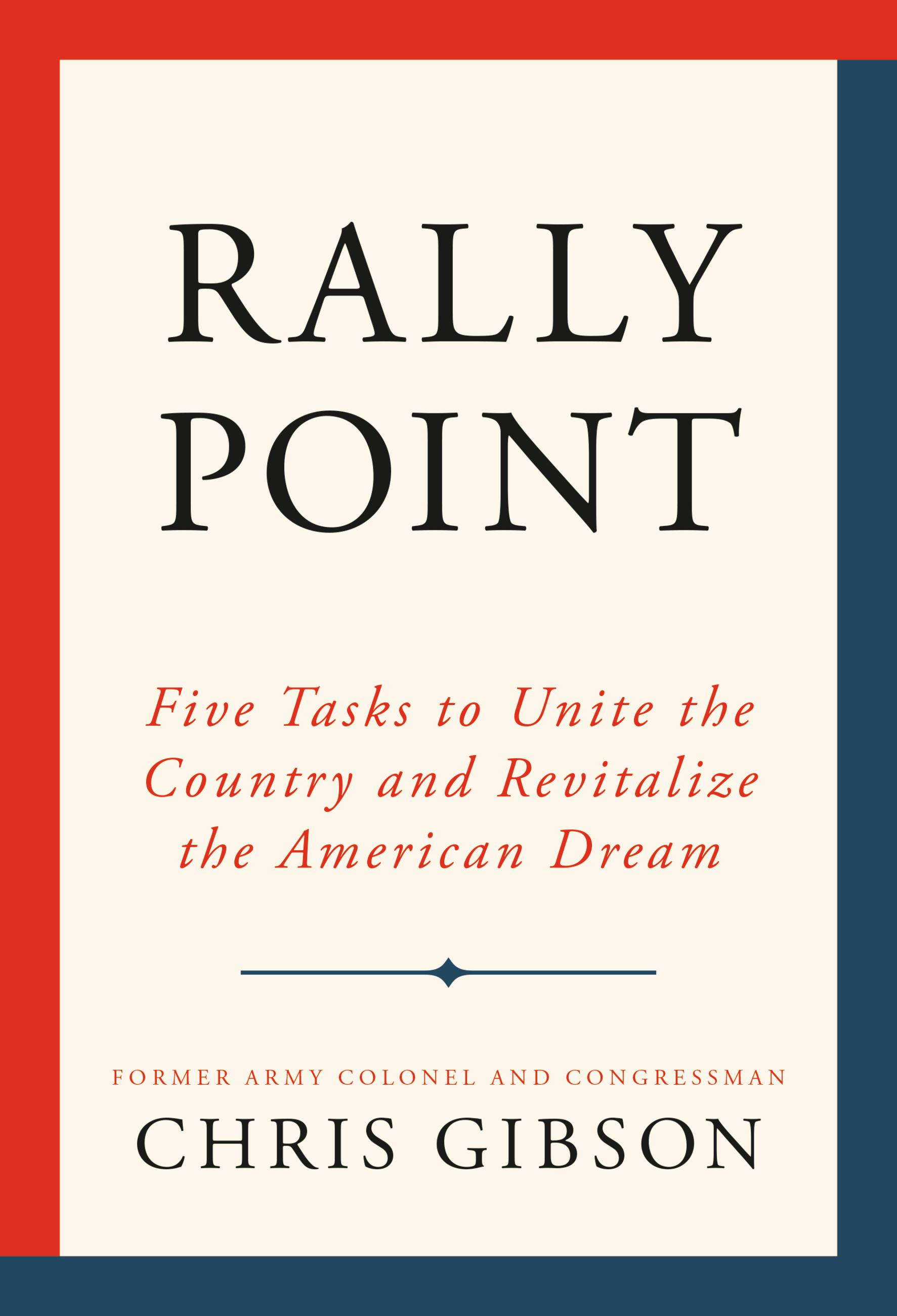
Rally Point A smart and surprising political inventory for how America can reunite and revitalize in a time of crisis. Written by an admired leader of the Republican party, Rally Point: Five Tasks to Unite the Country and Revitalize the American Dream looks past the 2016 election, past the finger pointing and conventional political thinking, to focus on clear, primary principles that conservatives must debate and defend to protect the future of America. Raised in a working-class family in upstate New York, the first in his family to go to college, paid for in part by his service in the National Guard, Chris Gibson rose from Private to Colonel in the Army, including combat command in the storied 82nd Airborne Division. RALLY POINT is his story: what he's learned from the "School of Hard Knocks" and how he's applied those precious life lessons during his service in Iraq and in Congress. Drawn from a deep appreciation of history and American exceptionalism, Gibson provides incisive and frank analysis of the current political environment, including President Trump, and provides a roadmap based on time-tested Founding principles to help unite our country and revitalize the American Dream. RALLY POINT is a thoughtful, compelling, enjoyable read - a must for serious-minded Americans looking for answers in this challenging political environment. POLITICAL SCIENCE,Political Ideologies,Conservatism & Liberalism
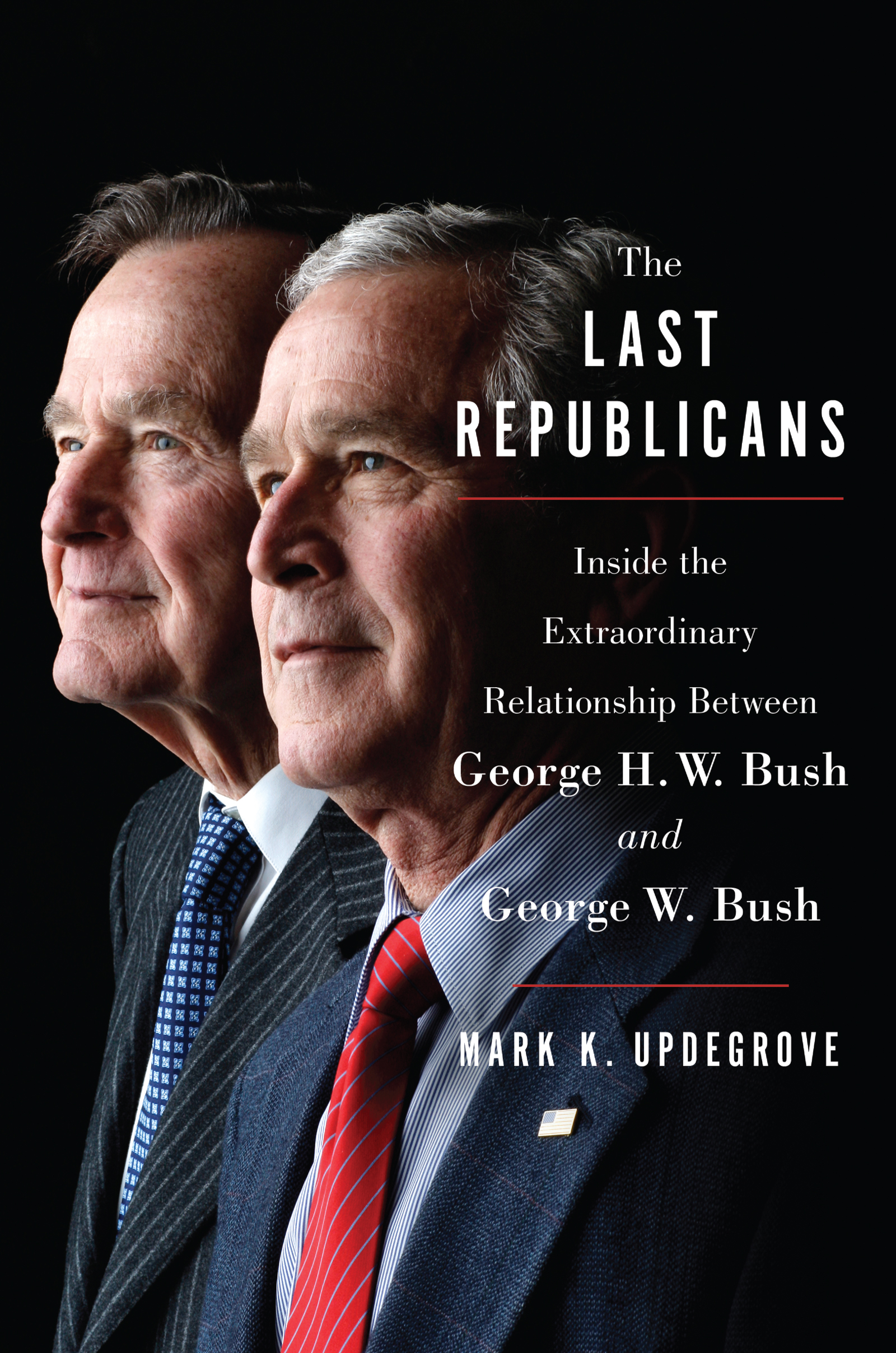
The Last Republicans A groundbreaking look at the lives of George H. W. Bush and George W. Bush, the most consequential father-son pair in American history, often in their own words. In this revealing, often poignant work, presidential historian Mark K. Updegrove tracks the two Bush presidents from their formative years through their post-presidencies and the failed presidential candidacy of Jeb Bush, derailing the Bush presidential dynasty. Drawing extensively on exclusive access and interviews with both Bush presidents, Updegrove reveals for the first time their influences and perspectives on each other’s presidencies; their views on family, public service, and America’s role in the world; and their unvarnished thoughts on Donald Trump and the radical transformation of the Republican Party he now leads. In 2016 George W. Bush lamented privately that he might be “the last Republican president.†Donald Trump’s election marked the end not only to the Bushes’ hold on the White House, but of a rejection of the Republican principles of civility and international engagement and leadership that the Bushes have long championed. The Last Republicans offers illuminating, moving portraits of the forty-first and forty-third presidents, as well as an elegy for the Republican “establishment,†which once stood for putting the interests of the nation over those of any single man. POLITICAL SCIENCE,Political Ideologies,Conservatism & Liberalism
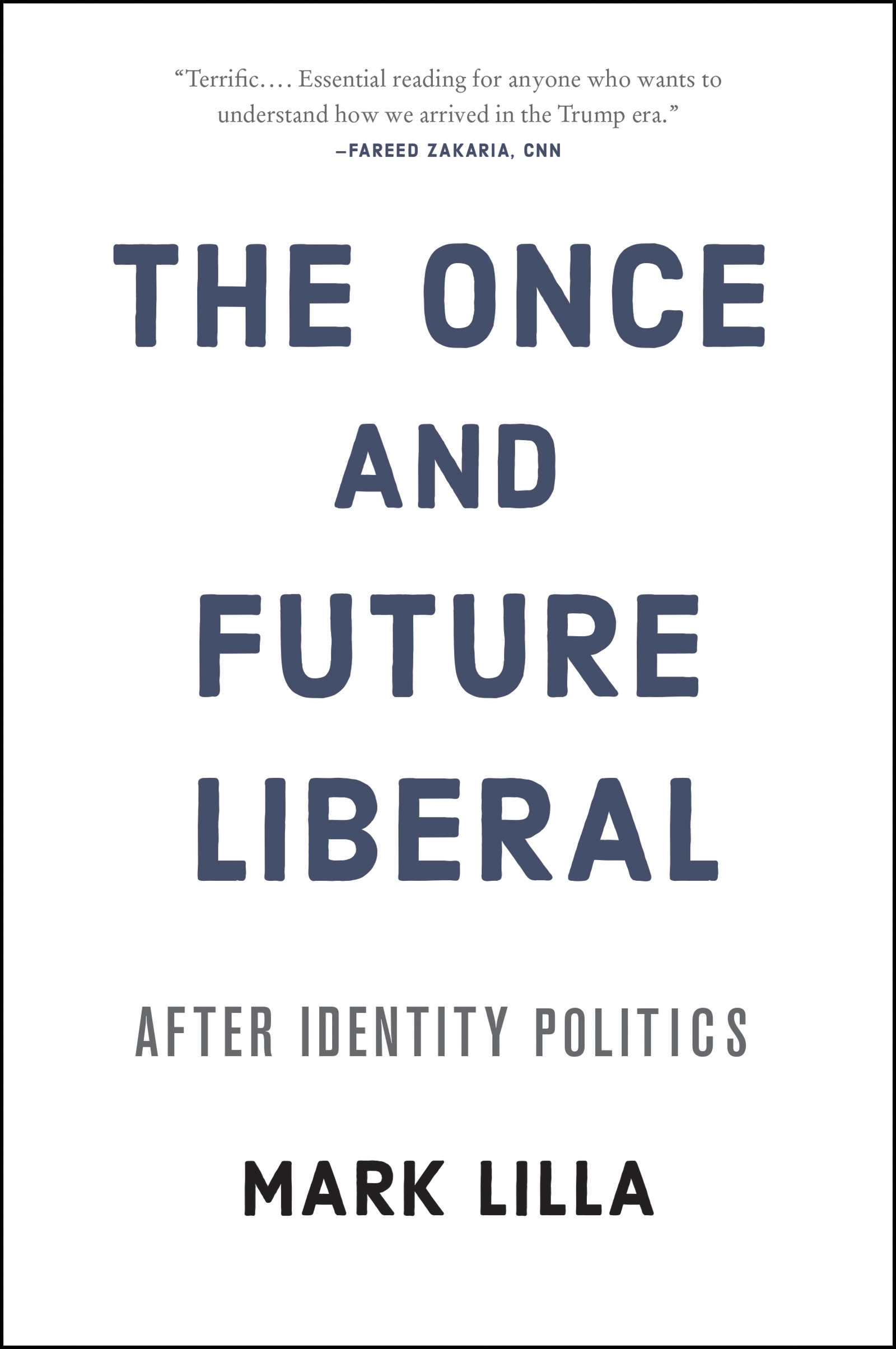
The Once and Future Liberal From one of the most internationally admired political thinkers, a controversial polemic on the failures of identity politics and what comes next for the left — in America and beyond. Following the shocking results of the US election of 2016, public intellectuals across the globe offered theories and explanations, but few were met with such vitriol, panic, and debate as Mark Lilla’s. The Once and Future Liberal is a passionate plea to liberals to turn from the divisive politics of identity and develop a vision of the future that can persuade all citizens that they share a common destiny. Driven by a sincere desire to protect society’s most vulnerable, the left has unwittingly balkanized the electorate, encouraged self-absorption rather than solidarity, and invested its energies in social movements rather than party politics. Identity-focused individualism has insidiously conspired with amoral economic individualism to shape an electorate with little sense of a shared future and near-contempt for the idea of the common good. Now is the time to re-build a sense of common feeling and purpose, and a sense of duty to one another. A fiercely argued, important book, enlivened by acerbic wit and erudition, The Once and Future Liberal is essential reading for our times. POLITICAL SCIENCE,Political Ideologies,Conservatism & Liberalism
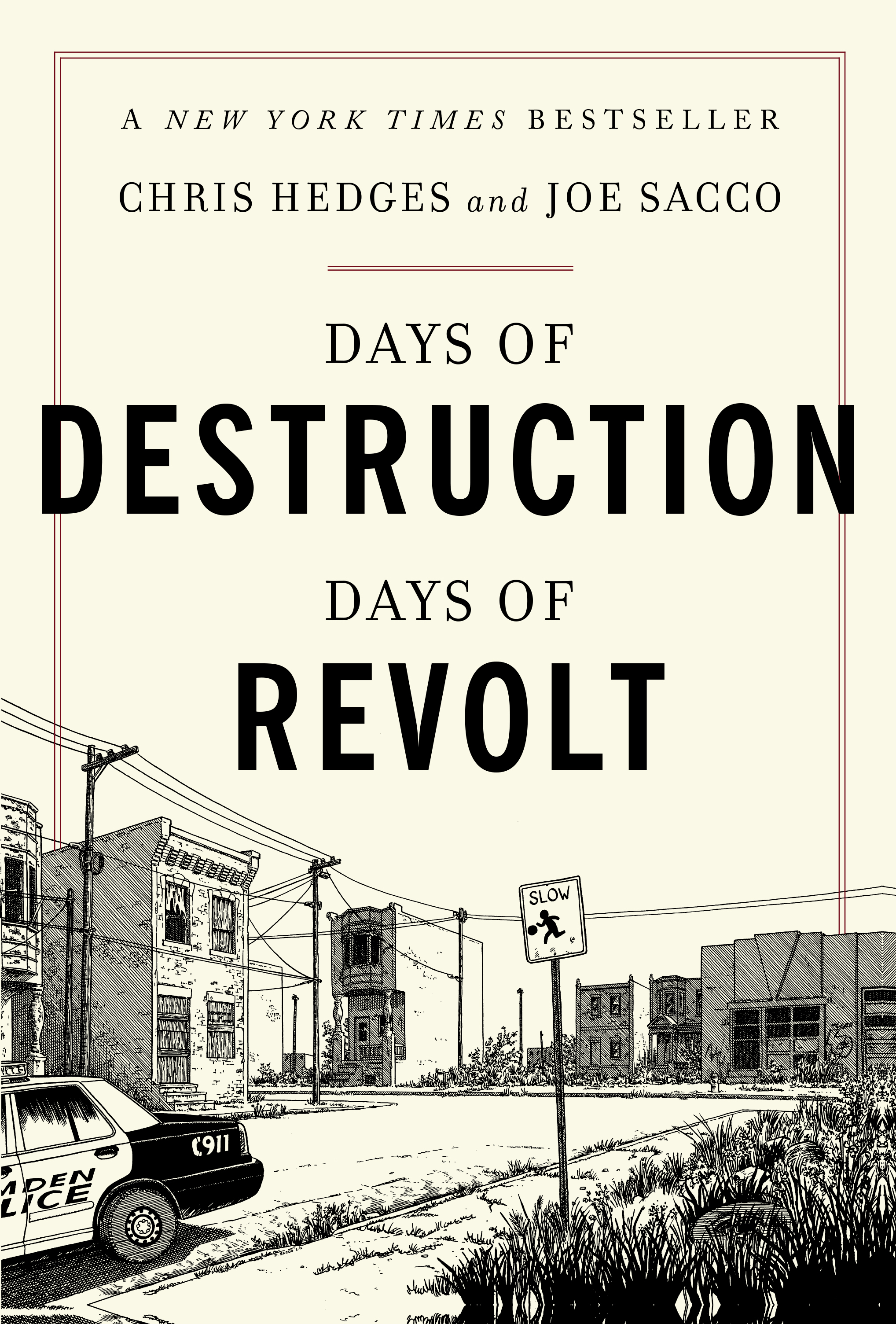
Days of Destruction, Days of Revolt Two years ago, Pulitzer Prize winner Chris Hedges and award-winning cartoonist and journalist Joe Sacco set out to take a look at the sacrifice zones, those areas in America that have been offered up for exploitation in the name of profit, progress, and technological advancement. They wanted to show in words and drawings what life looks like in places where the marketplace rules without constraints, where human beings and the natural world are used and then discarded to maximize profit. Days of Destruction, Days of Revolt is the searing account of their travels. The book starts in the western plains, where Native Americans were sacrificed in the giddy race for land and empire. It moves to the old manufacturing centers and coal fields that fueled the industrial revolution, but now lie depleted and in decay. It follows the steady downward spiral of American labor into the nation's produce fields and ends in Zuccotti Park where a new generation revolts against a corporate state that has handed to the young an economic, political, cultural and environmental catastrophe. POLITICAL SCIENCE,Political Ideologies,Conservatism & Liberalism

Dismantling America These wide-ranging essays -- on many individual political, economic, cultural and legal issues -- have as a recurring, underlying theme the decline of the values and institutions that have sustained and advanced American society for more than two centuries. This decline has been more than an erosion. It has, in many cases, been a deliberate dismantling of American values and institutions by people convinced that their superior wisdom and virtue must over-ride both the traditions of the country and the will of the people. Whether these essays (originally published as syndicated newspaper columns) are individually about financial bailouts, illegal immigrants, gay marriage, national security, or the Duke University rape case, the underlying concern is about what these very different kinds of things say about the general direction of American society. This larger and longer-lasting question is whether the particular issues discussed reflect a degeneration or dismantling of the America that we once knew and expected to pass on to our children and grandchildren. There are people determined that this country's values, history, laws, traditions and role in the world are fundamentally wrong and must be changed. Such people will not stop dismantling America unless they get stopped -- and the next election may be the last time to stop them, before they take the country beyond the point of no return. POLITICAL SCIENCE,Political Ideologies,Conservatism & Liberalism
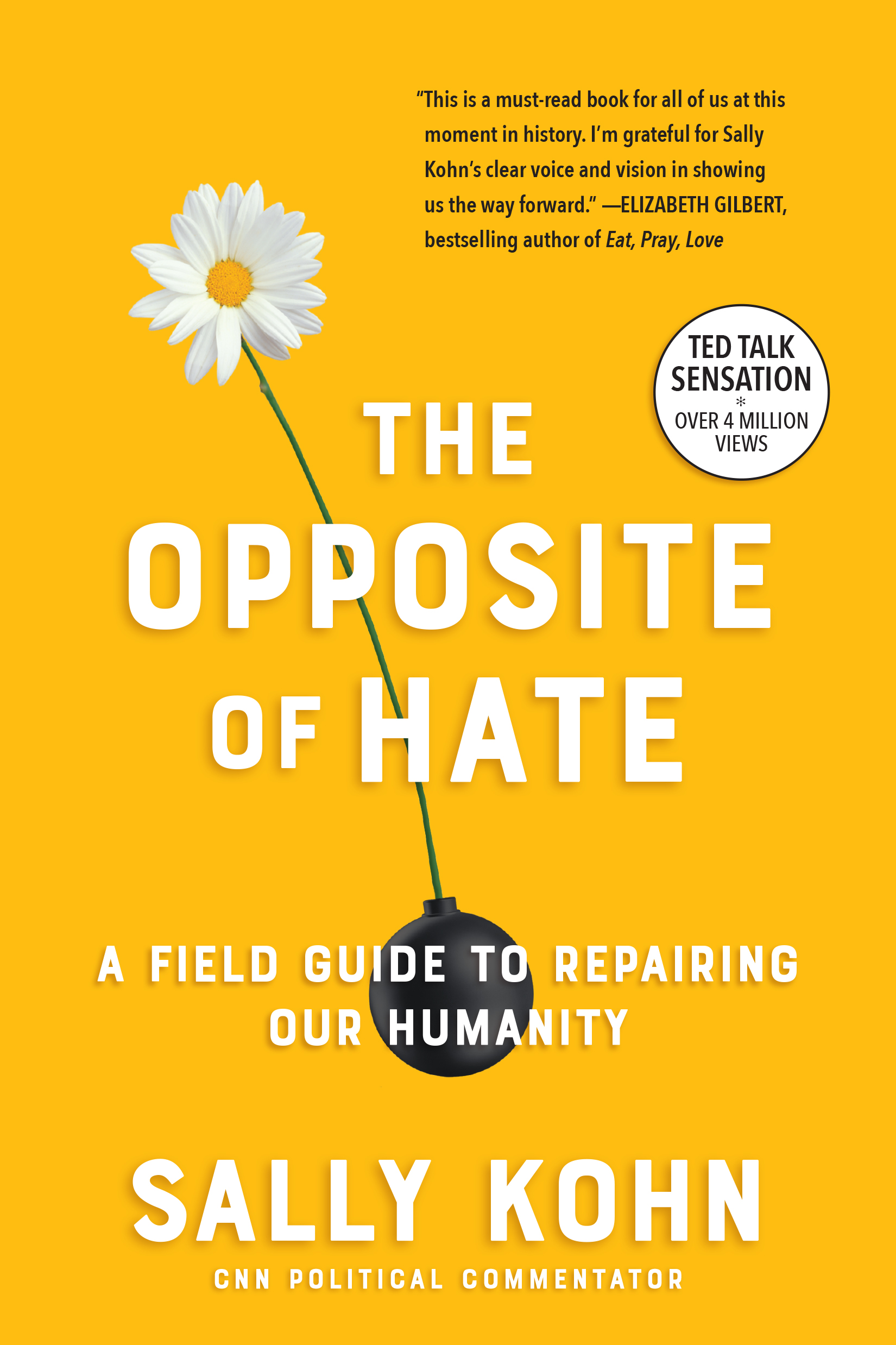
The Opposite of Hate “Brilliantly illustrates the immense and disarming power of changing course and driving not toward division, but toward civility and mutual respect.” --Ms. magazine As a progressive commentator on Fox News and now CNN, Sally Kohn has made a career out of bridging intractable political differences. In this age of dangerous partisan resentment and rising bigotry, she decided to investigate hate itself--to better consider how we can stop it. With her trademark humor and humanity, Kohn introduces us to leading researchers and scientists who are exploring the evolutionary and cultural roots of hate. She travels to Rwanda, to the Middle East, and across the United States, talking with former terrorists and reformed white supremacists, and even sitting down with some of her own Twitter trolls. What she discovers is surprising: All of us harbor hate but the powerful acknowledgment that we are all in this together can lead us out of the wilderness. The opposite of hate is connection. POLITICAL SCIENCE,Political Ideologies,Conservatism & Liberalism

Love Your Enemies NOW A NATIONAL BESTSELLER! To get ahead today, you have to be a jerk, right? Divisive politicians. Screaming heads on television. Angry campus activists. Twitter trolls. Today in America, there is an “outrage industrial complex†that prospers by setting American against American, creating a “culture of contemptâ€â€”the habit of seeing people who disagree with us not as merely incorrect, but as worthless and defective. Maybe, like more than nine out of ten Americans, you dislike it. But hey, either you play along, or you’ll be left behind, right? Wrong. In Love Your Enemies, the New York Times bestselling author and social scientist Arthur C. Brooks shows that abuse and outrage are not the right formula for lasting success. Brooks blends cutting-edge behavioral research, ancient wisdom, and a decade of experience of experience leading one of America’s top policy think tanks in a work that offers a better way to lead based on bridging divides and mending relationships. Brooks’ prescriptions are unconventional. To bring America together, we shouldn’t try to agree more. There is no need for mushy moderation, because disagreement is the secret to excellence. Civility and tolerance shouldn’t be our goals, because they are hopelessly low standards. And our feelings toward our foes are irrelevant; what matters is how we choose to act. Love Your Enemies offers a clear strategy for victory for a new generation of leaders. It is a rallying cry for people hoping for a new era of American progress. Most of all, it is a roadmap to arrive at the happiness that comes when we choose to love one another, despite our differences. POLITICAL SCIENCE,Political Ideologies,Conservatism & Liberalism
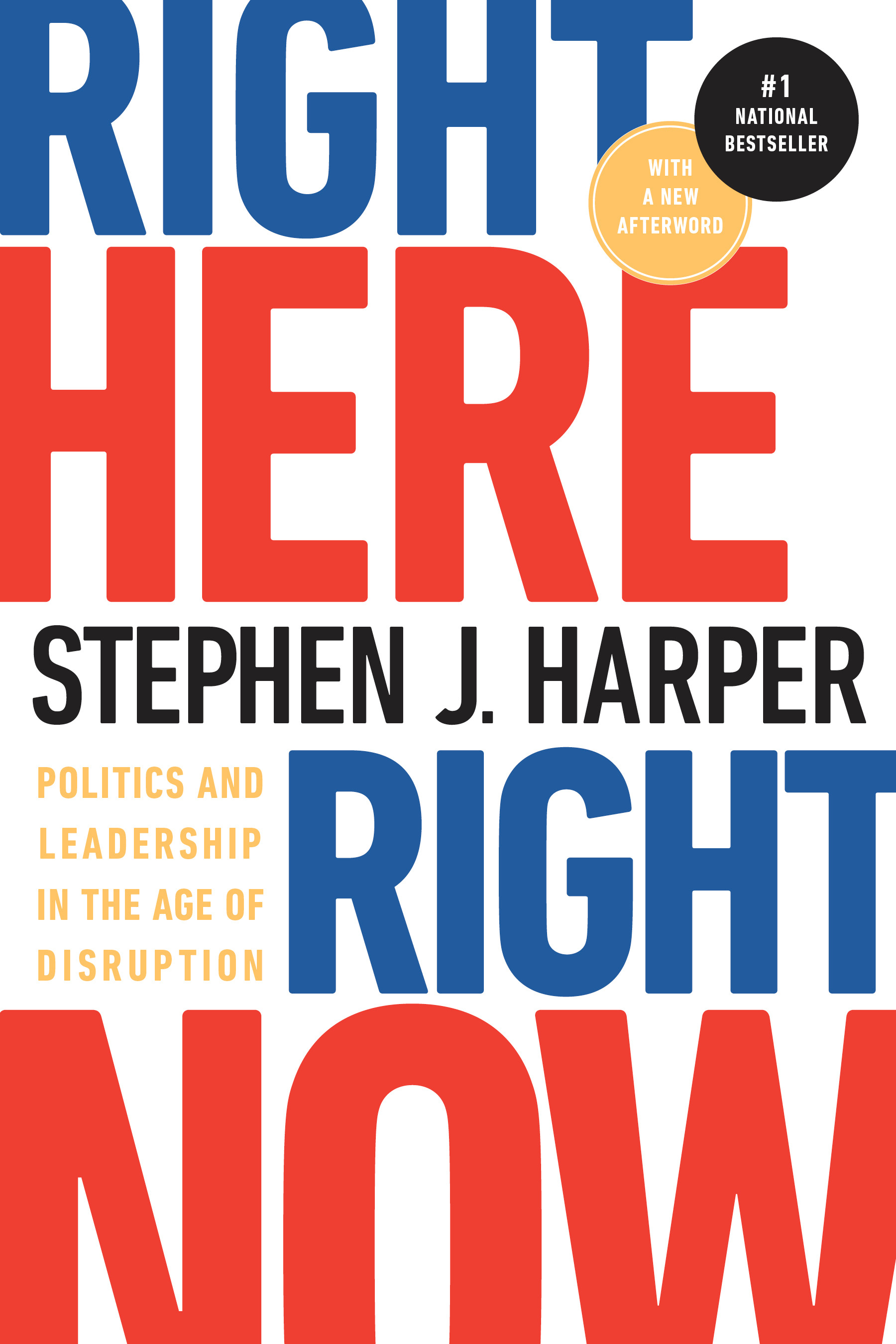
Right Here, Right Now In this timely and insightful new book, Stephen J. Harper, Canada's 22nd Prime Minister, draws on a decade of experience as a G-7 leader to help leaders in business and government understand, adapt, and thrive in an age of unprecedented disruption. The world is in flux. Disruptive technologies, ideas, and politicians are challenging business models, norms, and political conventions everywhere. How we, as leaders in business and politics, choose to respond matters greatly. Some voices refuse to concede the need for any change, while others advocate for radical realignment. But neither of these positions can sustainably address the legitimate concerns of disaffected citizens. Right Here, Right Now sets out a pragmatic, forward-looking vision for leaders in business and politics by analyzing how economic, social, and public policy trends--including globalized movements of capital, goods and services, and labour--have affected our economies, communities, and governments. Harper contends that Donald Trump's surprise election and governing agenda clearly signal that political, economic, and social institutions must be more responsive to legitimate concerns about public policy, market regulation, immigration, and technology. Urging readers to look past questions of style and gravitas, Harper thoughtfully examines the substantive underpinnings of how and why Donald Trump was able to succeed Barack Obama as President of the United States, and how these forces are manifesting themselves in other western democracies. Analyzing international trade, market regulation, immigration, technology, and the role of government in the digital economy, Harper lays out the case for pragmatic leadership as a proven solution to the uncertainty and risk that businesses and governments face today. POLITICAL SCIENCE,Political Ideologies,Conservatism & Liberalism

The Politically Incorrect Guide to the British Empire The British Empire, â€the biggest empire in historyâ€once ruled a quarter of the globe. It was built by an incredible array of swashbuckling soldiers and sailors, pirates and adventurers who finally get their due in H. W. Crocker III's panoramic and provocative view of four hundred years of history that will delight and amuse, educate and entertain. Strap on your pith helmet for a rollicking ride through some of history's most colorful events. Bet your teacher never told you: The Founding Fathers didn't rebel against British imperialism; they looked forward to the transfer of the great seat of Empire to America. The original Norman English invasion of Ireland was approved by the pope. Sir Charles Napier, commander in chief of the British Army in India, abolished the Hindu custom of widow-burning. Field Marshal Sir Gerald Templer's hearts and minds counter- insurgency strategy was instrumental in defeating the Communists in Malaya. The breakup of the British Empire led Winston Churchill to conclude that he had achieved nothing in his life. POLITICAL SCIENCE,Political Ideologies,Conservatism & Liberalism

The Politically Incorrect Guide to Climate Change *Updated to include new section on the Green New Deal!* "The climate scare ends with this book." —SEAN HANNITY "This book arms every citizen with a comprehensive dossier on just how science, economics, and politics have been distorted and corrupted in the name of saving the planet." —MARK LEVIN Less freedom. More regulation. Higher costs. Make no mistake: those are the surefire consequences of the modern global warming campaign waged by political and cultural elites, who have long ago abandoned fact-based science for dramatic fearmongering in order to push increased central planning. The Politically Incorrect Guide to Climate Change gives a voice -- backed by statistics, real-life stories, and incontrovertible evidence -- to the millions of "deplorable" Americans skeptical about the multibillion dollar "climate change" complex, whose claims have time and time again been proven wrong. POLITICAL SCIENCE,Political Ideologies,Conservatism & Liberalism

Defeating Jihad Now a New York Times bestseller! America is at war. The fight against global jihad has cost 7,000 American lives and almost $2 trillion, and yet, most Americans do not understand what is at stake. The public lacks knowledge and safety because two presidents and their administrations neglected the most basic strategic question: who is the enemy?Presidents Bush and Obama both named the global jihadi movementa movement with an intent to destroy the Westviolent extremism.†Their tidy term was an attempt to maintain peace with the Muslim community. But when they failed to appropriately name the enemy, they failed to fully understand Islamic extremism. This failure is why the U.S. has been in Afghanistan for sixteen years with no end in sight. But this war is eminently winnable if we remove our ideological blinders, accurately name our enemy, and draw up a strategy to defeat the ideas that inspire terrorism. So says Dr. Sebastian Gorka, one of the most experienced and sought-after authorities on counterterrorism. Dr. Gorka has been one of the intelligence community’s go-to experts on counterterrorism since 9/11. He’s been called to brief Congress and the Marine Corps and was asked to analyze the Patriot’s Day Boston Marathon Bombing for the US government. Dr. Gorka’s report for the trial of Dzhokhar "Jahar" Tsarnaev was widely circulated in counterterrorism circles and the media because it accurately painted a picture, not of a teenager on the cover of Rolling Stone, but of a terrorist. Dr. Gorka is respected by peers because he understands our enemy is not "terror" or "violent extremism." Our enemy is the global jihadi movement, a modern totalitarian ideology rooted in the doctrines and martial history of Islam whose goals are to build an empire, suppress false Muslims,†and engage in guerilla warfare against infidels. Taking his cue from the formerly top-secret analyses that shaped the U.S. response to the communist threat, Dr. Gorka has produced a compelling profile of the jihadi movementits mind and motivationand a plan to defeat it. POLITICAL SCIENCE,Political Ideologies,Conservatism & Liberalism

Bannon He helped engineer one of the greatest upsets in political history—the election of Donald J. Trump as president of the United States. Now, after a short and turbulent tenure in the White House, Steve Bannon is working on the outside to propel forward his populist agenda even when it puts him at odds with the Trump administration. Unafraid to speak the truth and unwilling to back down, Bannon has made headlines in recent months for slamming the Trump administration's approach to North Korea and China, backing controversial Senate candidate Roy Moore at all costs, and calling members of Trump's circle—including Trump's son Don Jr. and his son-in-law Jared Kushner—"treasonous" for meeting with Russians during the election. What is Steve Bannon trying to achieve? Is he a political genius with a promising ideology, or a muckraker without allegiances? In Bannon: Always the Rebel, veteran White House reporter Keith Koffler sits down for hours of interviews with Steve Bannon and gets the embattled former White House advisor talking about his plans, his current thinking about the Trump White House, and the reasons he's still fighting. "Keith Koffler's book will help you understand why Steve Bannon still matters, and why he is one of the most powerful and important men outside the Oval Office." —SEBASTIAN GORKA, Ph.D., former deputy assistant to President Trump, author of Defeating Jihad, and chief strategist of the Make America Great Again Coalition. POLITICAL SCIENCE,Political Ideologies,Conservatism & Liberalism
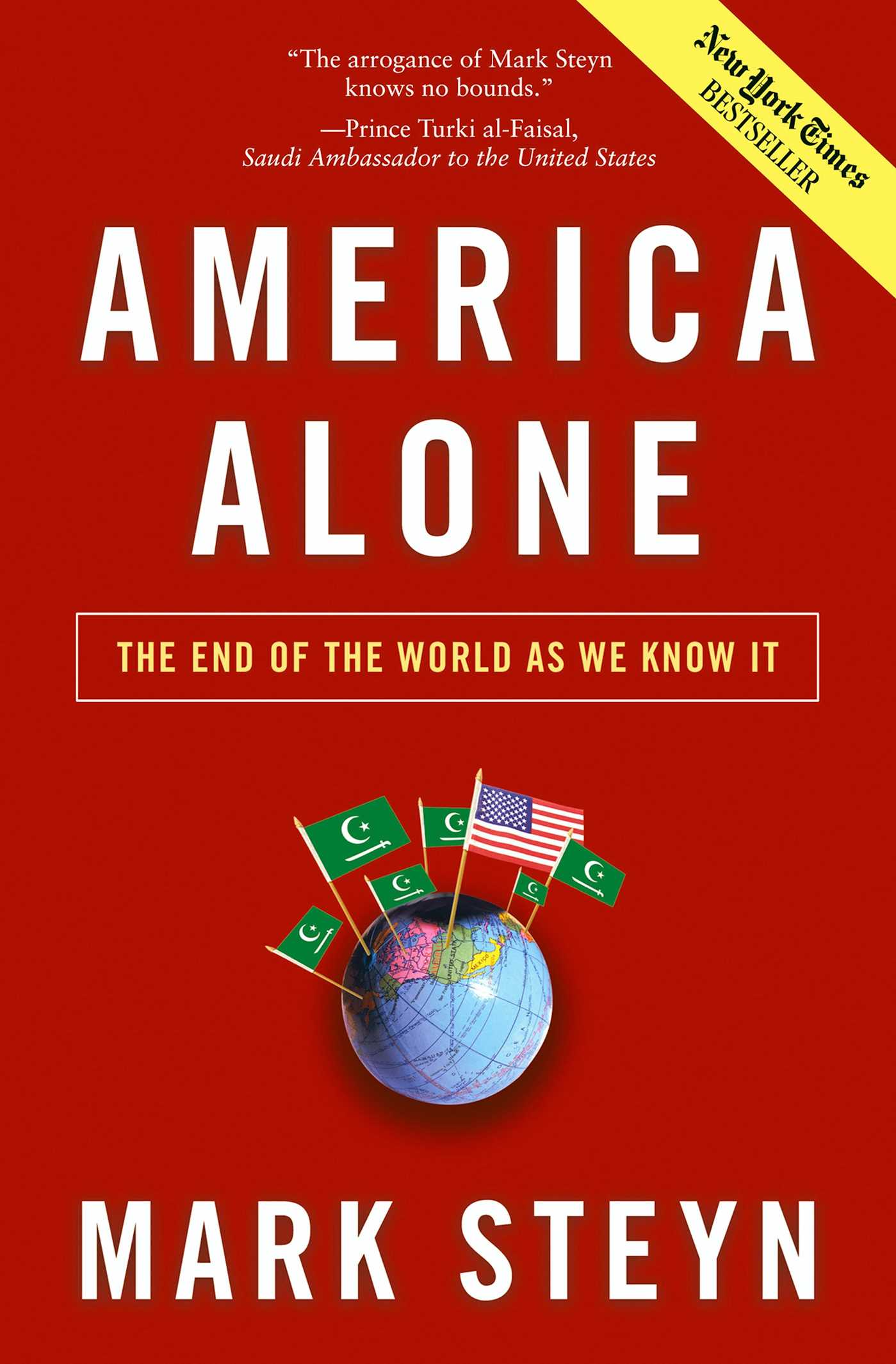
America Alone "Mark Steyn is a human sandblaster. This book provides a powerful, abrasive, high-velocity assault on encrusted layers of sugarcoating and whitewash over the threat of Islamic imperialism. Do we in the West have the will to prevail?" - MICHELLE MALKIN, New York Times bestselling author of Unhinged "Mark Steyn is the funniest writer now living. But don't be distracted by the brilliance of his jokes. They are the neon lights advertising a profound and sad insight: America is almost alone in resisting both the suicide of the West and the suicide bombing of radical Islamism." - JOHN O'SULLIVAN, editor at large, National Review IT'S THE END OF THE WORLD AS WE KNOW IT..... Someday soon, you might wake up to the call to prayer from a muezzin. Europeans already are. And liberals will still tell you that "diversity is our strength"--while Talibanic enforcers cruise Greenwich Village burning books and barber shops, the Supreme Court decides sharia law doesn't violate the "separation of church and state," and the Hollywood Left decides to give up on gay rights in favor of the much safer charms of polygamy. If you think this can't happen, you haven't been paying attention, as the hilarious, provocative, and brilliant Mark Steyn--the most popular conservative columnist in the English-speaking world--shows to devastating effect. The future, as Steyn shows, belongs to the fecund and the confident. And the Islamists are both, while the West is looking ever more like the ruins of a civilization. But America can survive, prosper, and defend its freedom only if it continues to believe in itself, in the sturdier virtues of self-reliance (not government), in the centrality of family, and in the conviction that our country really is the world's last best hope. Mark Steyn's America Alone is laugh-out-loud funny--but it will also change the way you look at the world. POLITICAL SCIENCE,Political Ideologies,Conservatism & Liberalism

America #1 New York Times Bestseller Is America a source of pride, as Americans have long held, or shame, as Progressives allege? Beneath an innocent exterior, are our lives complicit in a national project of theft, expropriation, oppression, and murder, or is America still the hope of the world? Dinesh D'Souza says these questions are no mere academic exercise. It is the Progressive view that is taught in our schools, that is preached by Hollywood, and that shapes the policies of the Obama administration. If America is a force for inequality and injustice in the world, its power deserves to be diminished; if traditional America is based on oppression and theft, then traditional America must be reformedand the federal government can do the reforming. In America: Imagine a World without Her D'Souza offers a passionate and sharply reasoned defense of America, knocking down every important accusation made by Progressives against our country. Provocative in its analysis, stunning in its conclusions, Dinesh D'Souza's America is a new classic. POLITICAL SCIENCE,Political Ideologies,Conservatism & Liberalism

Donald Drains the Swamp The cavemen need help. Their King has forgotten all about them, thanks to the swamp creatures who surround the castle. “They’re slippery!â€76' " m ujmmmmmtk, “—and scaly!†“and SLIMY!" Donald is just a caveman. But when the people ask for his help, he realizes there’s only one way to save the kingdom: DRAIN… THE… SWAMP! Written by #1 national bestselling author and humorist Eric Metaxas and illustrated by award-winning artist Tim Raglin, Donald Drains the Swamp is a whimsical parable for the current political moment. POLITICAL SCIENCE,Political Ideologies,Conservatism & Liberalism

Russell Kirk's Concise Guide to Conservatism The modern conservative intellectual movement began in 1953 with Russell Kirk’s groundbreaking book The Conservative Mind. Four years later, he published a pithy, wry, philosophical summary of what conservatism really means. Originally titled The Intelligent Woman's Guide to Conservatism, this little book was essentially a popular version of The Conservative Mind. Now, a century after its author’s birth, this neglected gem has been recovered. It remains what Kirk intended it to be: an accessible introduction to conservative ideas, especially for the young. With a new title and an introduction by the eminent intellectual historian Wilfred M. McClay, Russell Kirk’s Concise Guide to Conservatism arrives with uncanny timing. The movement that Kirk defined in 1953 is today so contested and fragmented that no one seems able to say with confidence what conservatism means. This book, as fresh and prophetic as the day it was published sixty years ago, is a reminder that no one can match Russell Kirk in engaging people’s minds and imaginations—an indispensable task in reviving our civilization. POLITICAL SCIENCE,Political Ideologies,Conservatism & Liberalism
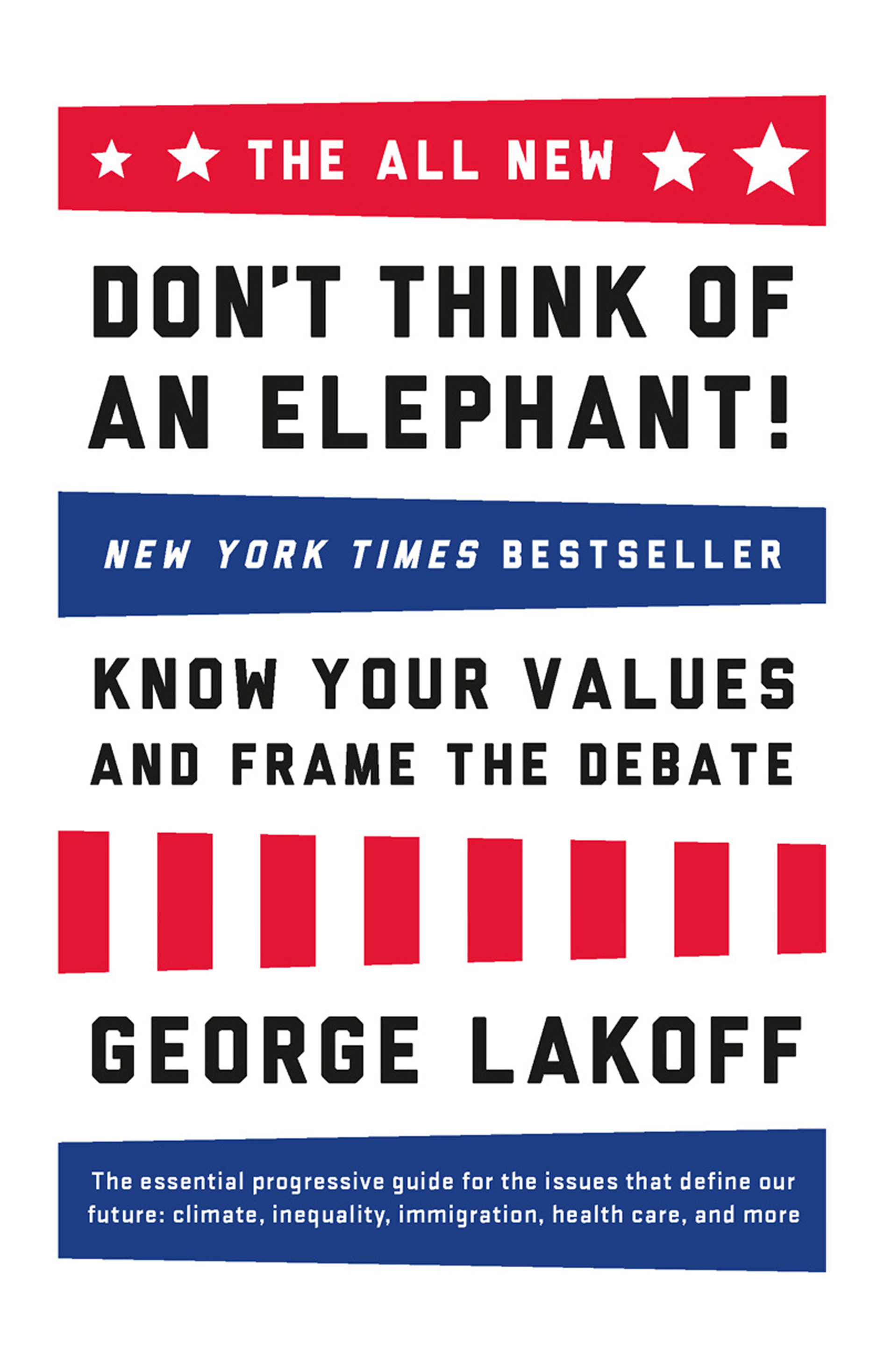
The ALL NEW Don't Think of an Elephant! Ten years after writing the definitive, international bestselling book on political debate and messaging, George Lakoff returns with new strategies about how to frame today’s essential issues. Called the “father of framing†by The New York Times, Lakoff explains how framing is about ideas—ideas that come before policy, ideas that make sense of facts, ideas that are proactive not reactive, positive not negative, ideas that need to be communicated out loud every day in public. The ALL NEW Don’t Think of an Elephant! picks up where the original book left off—delving deeper into how framing works, how framing has evolved in the past decade, how to speak to people who harbor elements of both progressive and conservative worldviews, how to counter propaganda and slogans, and more. In this updated and expanded edition, Lakoff, urges progressives to go beyond the typical laundry list of facts, policies, and programs and present a clear moral vision to the country—one that is traditionally American and can become a guidepost for developing compassionate, effective policy that upholds citizens’ well-being and freedom. POLITICAL SCIENCE,Political Ideologies,Conservatism & Liberalism
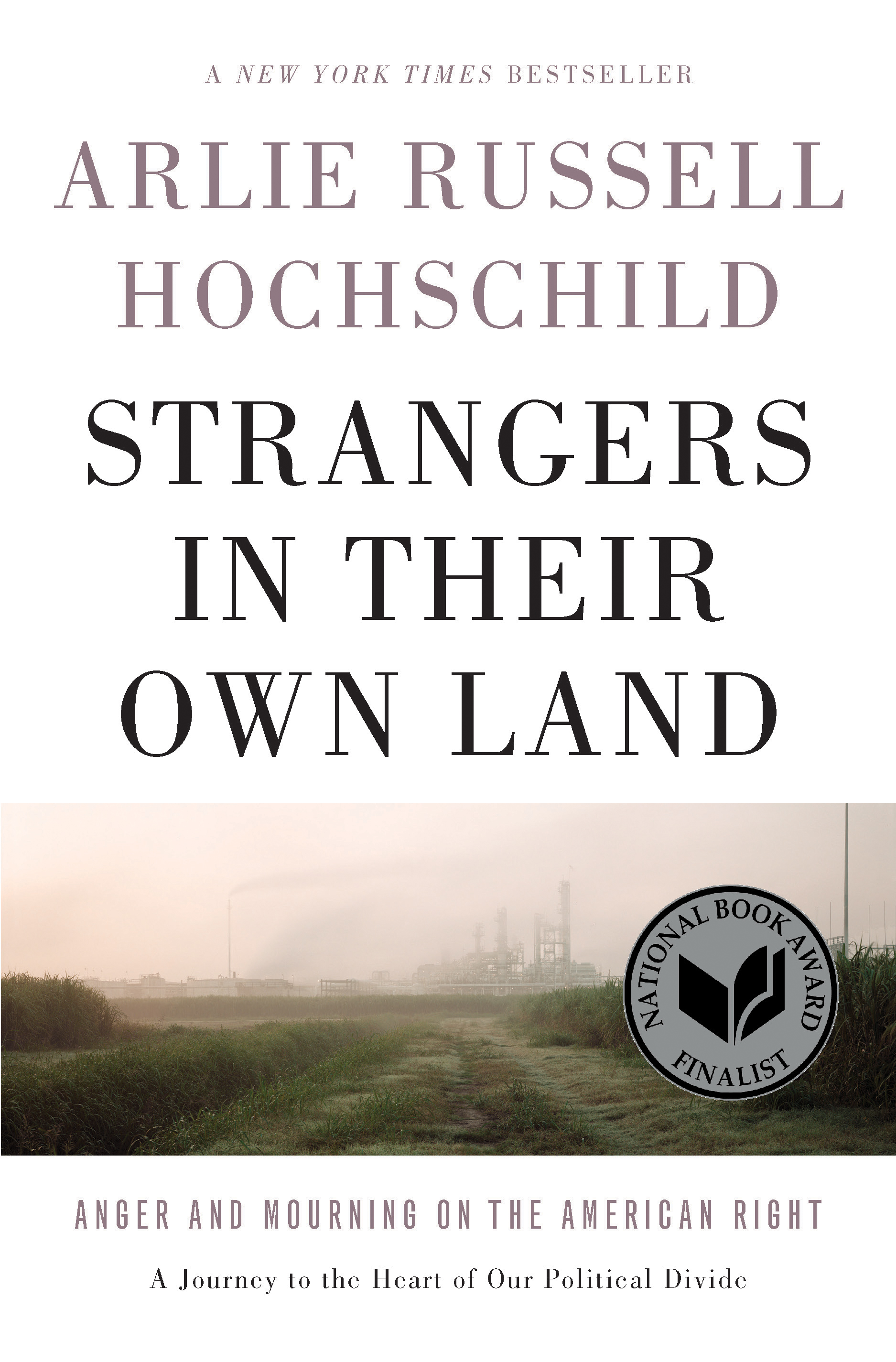
Strangers in Their Own Land The National Book Award Finalist and New York Times bestseller that became a guide and balm for a country struggling to understand the election of Donald Trump "A generous but disconcerting look at the Tea Party. . . . This is a smart, respectful and compelling book." —Jason DeParle, The New York Times Book Review When Donald Trump won the 2016 presidential election, a bewildered nation turned to Strangers in Their Own Land to understand what Trump voters were thinking when they cast their ballots. Arlie Hochschild, one of the most influential sociologists of her generation, had spent the preceding five years immersed in the community around Lake Charles, Louisiana, a Tea Party stronghold. As Jedediah Purdy put it in the New Republic, “Hochschild is fascinated by how people make sense of their lives. . . . [Her] attentive, detailed portraits . . . reveal a gulf between Hochchild’s ‘strangers in their own land’ and a new elite.†Already a favorite common read book in communities and on campuses across the country and called “humble and important†by David Brooks and “masterly†by Atul Gawande, Hochschild’s book has been lauded by Noam Chomsky, New Orleans mayor Mitch Landrieu, and countless others. The paperback edition features a new afterword by the author reflecting on the election of Donald Trump and the other events that have unfolded both in Louisiana and around the country since the hardcover edition was published, and also includes a readers’ group guide at the back of the book. POLITICAL SCIENCE,Political Ideologies,Conservatism & Liberalism

Obstruction of Justice Investigative reporter Luke Rosiak is being hailed as “one of the smartest, most diligent reporters in Washington†(TUCKER CARLSON) and “a bulldog†(DANA LOESCH) for uncovering “what is possibly the largest scandal and coverup in the history of the United States House of Representatives†(NEWT GINGRICH). It’s like something out of a spy novel: In the heat of the 2016 election, an unvetted Pakistani national with a proclivity for blackmail gained access to the computer files of one in five Democrats in the House of Representatives. He and his family lifted data off the House network, stole the identity of an intelligence specialist, and sent congressional electronic equipment to foreign officials. And that was only the beginning. Rather than protect national security, Congress and the Justice Department schemed to cover up a politically inconvenient hack and an underlying fraud on Capitol Hill involving dozens of Democrats' offices. Evidence disappeared, witnesses were threatened, and the supposed watchdogs in the media turned a blind eye. Combining tenacious investigative reporting and high-tech investigative techniques, Luke Rosiak began ferreting out the truth, and found himself face to face with the "Deep State," observing how Nancy Pelosi's Democrats manipulated the Department of Justice, the media, and even Republican leadership to sabotage the investigation into what Newt Gingrich calls possibly the biggest congressional scandal in history. POLITICAL SCIENCE,Political Ideologies,Conservatism & Liberalism

Still Winning In this stirring true account of American leadership, learn how President Trump will put an end to a corrupt system of government ruled by the establishment and special interests. Still Winning is the story of the unlikeliest of heroes who emerged from the unlikeliest of places to take up the impossible cause of a truly forgotten people. They are people who love their country, trust their higher God, obey laws and will do anything for their family and neighbors. They are the very people the Founders envisioned when they hatched the radical idea of self-governance. This is the story of a Leviathan government -- the most powerful political force in the history of mankind -- that has become dangerously unmoored from the people it represents. It is the story of how elites and the politically comfortable controlling both parties in Washington have utterly lost touch. They don't even realize how much the people they represent despise the uncontrollable Leviathan. The establishment has tried their best to ignore Donald Trump -- except to brand him as a racist, a xenophobe, an isolationist, and a dangerous, violence-inciting war monger. All standards of reporting vanished. In the era of Trump, no sort of criticism was off-limits. They openly mocked his looks, ridiculed his private business accomplishments, pilloried his family and children and made fun of his foreign-born wife for her accent! The Leviathan has grown untamable. Democrats and Republicans run for office year after year on promises they have no intention of keeping. Neither side wants to fix a single problem. The whole thing has become one giant ungovernable, corrupt Ponzi scheme that -- one day -- will come crashing down. Charles Hurt advocates for the "Nuclear Option" for dealing with this mess: just blow the whole damned thing up. Whatever is presidential or diplomatic, let's try the opposite. Whatever these people in Washington find most horrifying, let's try that. Finally, the multi-headed Leviathan swamp monster has met the perfect dragon slayer in Donald Trump. Still Winning examines each corrupt head of this Leviathan, and why Donald Trump is the only good answer to fixing it. POLITICAL SCIENCE,Political Ideologies,Conservatism & Liberalism

The War for America's Soul “Take it from someone who has been on the inside, who understands the fight we are currently in, and who knows what must be done to save our country. Dr. Sebastian Gorka’s latest book, The War for America’s Soul, leverages the former White House strategist’s expertise, driven by his determination to preserve what made America great in the first place.†— MARK LEVIN Our country is at war with itself. On one side are American patriots, dedicated to freedom under the Constitution; on the other side are leftists campaigning not just to win elections, but to radically transform the nation. In this political war for the soul of our country, America’s patriots need a strategist with a blueprint for victory. Luckily, we have such a man in Dr. Sebastian Gorka—a former strategist for President Trump and now a nationally syndicated radio host and a fearless culture warrior. In his essential new book, The War for America’s Soul, Dr. Gorka shows how America’s elite—in both parties—betrayed our heartland, sabotaged the American dream, and accepted national decline as inevitable. It took a candidate with remarkable vision, dauntless courage, and unbreakable determination to change the narrative. That man was Donald Trump. A candidate who owed no favors to special interests, Trump articulated a new American nationalism that has been an extraordinary force for economic and political renewal. POLITICAL SCIENCE,Political Ideologies,Conservatism & Liberalism

Tipping Points NATIONAL BESTSELLER "Terrific." — BEN SHAPIRO "Outstanding." — DANA LOESCH The Left is on the attack, and the war for our country is at a crucial tipping point. Liberals know they’re within reach of radically transforming America. They don’t like the U.S. Constitution. They’re allergic to Americans’ “gun culture.†They find our faith and our devotion to family distasteful. And our commitment to liberty positively sends them into a panic. As soon as the Democrats get power anywhere, they stand ready to throw our God-given rights under the bus of political correctness, transgender insanity, and socialism (the economic system that always promises equality and utopia, but somehow always delivers resentment, poverty, and decay). So how can we tip the momentum back in our favor? How can we fight effectively for freedom, the U.S. Constitution, limited government, faith and family, and the survival of the American Republic? Liz Wheeler to the rescue! The popular host of One America News Network’s "Tipping Point with Liz Wheeler" is a brilliant and highly effective debater who shows how we can go on the rhetorical attack against the Left—and win—with a multi-technique program for catching the Left in their inconsistencies and under-handed schemes and skewering them for their bold-faced lies. In Tipping Points: How to Topple the Left’s House of Cards , Liz Wheeler identifies the five “Tipping Points†where liberals are poised to win, trains you in her proven debating techniques, and deputizes you to take up arms in the fight for our nation’s heart and soul. It’s training you need right now, today. Our country is at a tipping point. And make no mistake—if the Left isn’t defeated, they’re taking down America. POLITICAL SCIENCE,Political Ideologies,Conservatism & Liberalism

Radicals, Resistance, and Revenge Picking up where her #1 New York Times bestseller, Liars, Leakers, and Liberals left off, Judge Jeanine Pirro exposes the latest chapter in the unfolding liberal attack on our most basic values. Donald Trump's presidency has been under siege by the Left and their Deep State fellow travelers who concocted an outrageous case of conspiracy with Russia to keep him from doing what he was elected to do: secure America's borders, revive its economy, drain the Washington DC swamp, and restore our constitutional republic. Overturning presidential elections, nationalizing private industries like healthcare and education, destroying America's borders, erasing its national identity, and effectively silencing conservative voices in the cybersphere and public square are a few examples of the lengths to which the far-left progressives and socialists will go to destroy the America we love. Radicals, Resistance, and Revenge features Judge Jeanine's keen analysis of explosive information about the anti-Trump conspirators, their corrupt methods and possible crimes, and the Left's subversive plot against the foundation of American liberty. Judge Jeanine is sounding the alarm and calling out those who despise our most cherished ideals and institutions to warn patriotic Americans before it's too late. POLITICAL SCIENCE,Political Ideologies,Conservatism & Liberalism

Open Borders Inc. "Michelle Malkin’s latest book is required reading for anyone wishing to understand the forces and interests behind the open borders and mass migration lobby." —Pawel Styrna, ImmigrationReform.com Follow the money, find the truth. That’s Michelle Malkin’s journalistic mantra, and in her stunning new book, Open Borders Inc., she puts it to work with a shocking, comprehensive exposé of who’s behind our immigration crisis. In the name of compassion—but driven by financial profit—globalist elites, Silicon Valley, and the radical Left are conspiring to undo the rule of law, subvert our homeland security, shut down free speech, and make gobs of money off the backs of illegal aliens, refugees, and low-wage guest workers. Politicians want cheap votes or cheap labor. Church leaders want pew-fillers and collection plate donors. Social justice militants, working with corporate America, want to silence free speech they deem “hateful,†while raking in tens of millions of dollars promoting mass, uncontrolled immigration both legal and illegal. Malkin names names—from Pope Francis to George Clooney, from George Soros to the Koch brothers, from Jack Dorsey to Tim Cook and Mark Zuckerberg. Enlightening as it is infuriating, Open Borders Inc. reveals the powerful forces working to erase America. POLITICAL SCIENCE,Political Ideologies,Conservatism & Liberalism

Guilty By Reason of Insanity "Today’s Democrats are pushing policies that are simply insane, and David Limbaugh proves it in his terriffic, and tremendously important, new book, Guilty by Reason of Insanity." — MARK LEVIN "Few pundits can match David Limbaugh for research, depth of knowledge, and political insight, and in this book, perhaps his best political book, he shows how the Democrat Party has completely lost its mind." — SEAN HANNITY The left has truly lost its mind. The party out of power used to be “the loyal opposition.†No longer. Now it’s “the Resistance.†The left, abandoning any pretense of fairness and decency, has declared political war on President Trump. Waged by a stunningly broad array of militants—the Democratic Party, countless left-wing interest groups, radical academics, the liberal mainstream media, Antifa shock troops, Hollywood, and the tech oligarchs—this political war is aimed not only at conservative ideas but also at Trump supporters, even teenagers wearing MAGA hats. In his shocking new book, Guilty by Reason of Insanity , national #1 bestselling author David Limbaugh explains how the left lost its mind—and the threat it now poses to us all. No book you read this year could be more important. POLITICAL SCIENCE,Political Ideologies,Conservatism & Liberalism

Cop Under Fire America has become increasingly divided and polarized in recent years. With growing racial tension, animosity toward law enforcement professionals, government corruption, and disregard for the constitutional process, there seems to be no easy answer in sight. But Milwaukee County Sheriff David Clarke knows where we must begin: we must stop blaming others; look at our problems with open eyes; take ownership of our family, community, and country; and turn to God for solutions. Deeply rooted in Sheriff Clarke's personal life story, this book is not a dry recitation of what has gone wrong in America with regard to race. It's about the issues that deeply affect us today-both personally and politically-and how we can rise above our current troubles to once again be a truly great people in pursuit of liberty and justice for all. POLITICAL SCIENCE,Political Ideologies,Conservatism & Liberalism
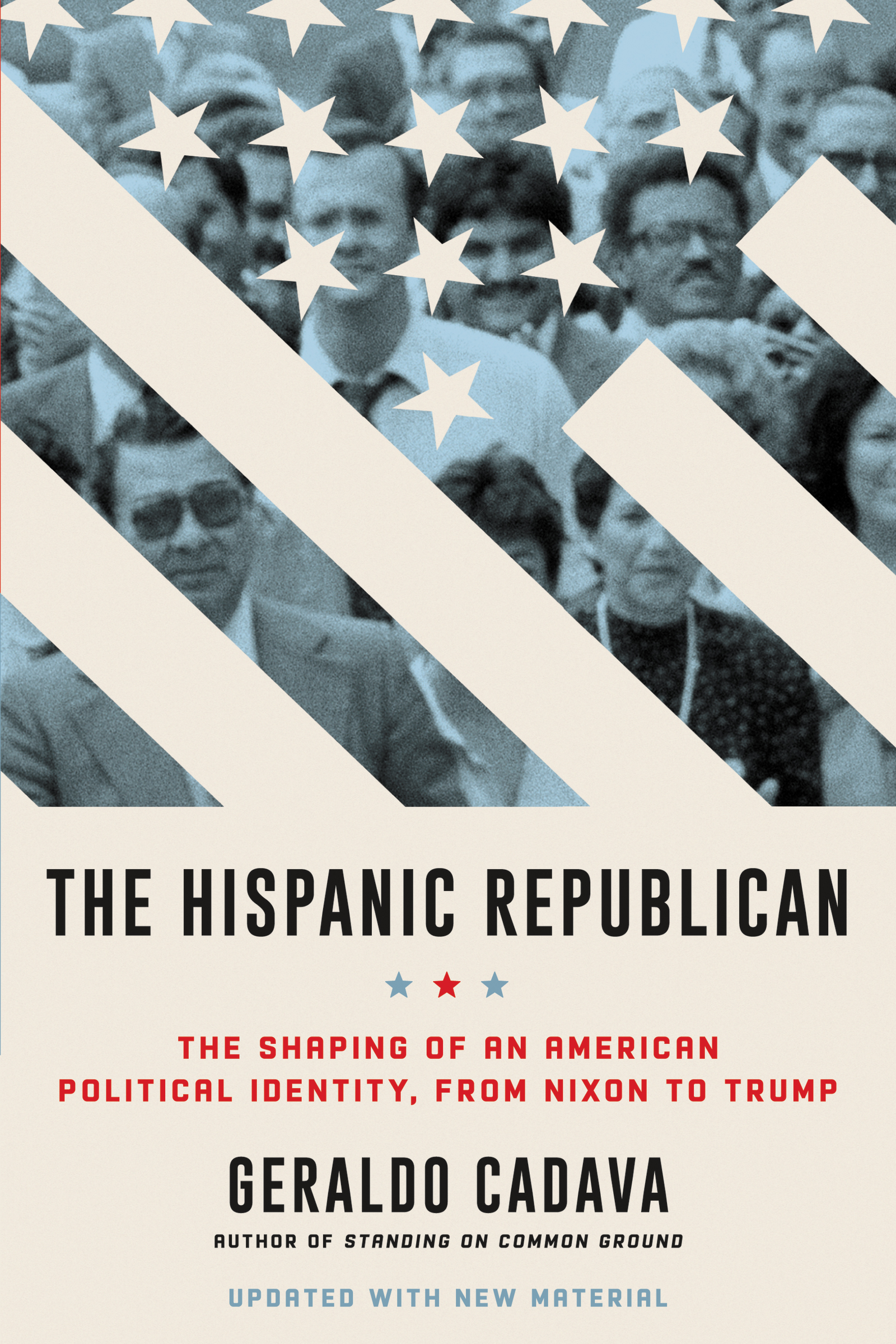
The Hispanic Republican An illuminating and thought-provoking history of the growth of Hispanic American Republican voters in the past half century and their surprising impact on US politics In the lead-up to every election cycle, pundits predict that Latino Americans will overwhelmingly vote in favor of the Democratic candidate. And it’s true—Latino voters do tilt Democratic. Hillary Clinton won the Latino vote in a “landslide,†Barack Obama “crushed†Mitt Romney among Latino voters in his reelection, and, four years earlier, the Democratic ticket beat the McCain-Palin ticket by a margin of more than two to one. But those numbers belie a more complicated picture. Because of decades of investment and political courtship, as well as a nuanced and varied cultural identity, the Republican party has had a much longer and stronger bond with Hispanics. How is this possible for a party so associated with draconian immigration and racial policies? In The Hispanic Republican, historian and political commentator Geraldo Cadava illuminates the history of the millions of Hispanic Republicans who, since the 1960s, have had a significant impact on national politics. Intertwining the little understood history of Hispanic Americans with a cultural study of how post–World War II Republican politicians actively courted the Hispanic vote during the Cold War (especially Cuban émigrés) and during periods of major strife in Central America (especially during Iran-Contra), Cadava offers insight into the complicated dynamic between Latino liberalism and conservatism, which, when studied together, shine a crucial light on a rapidly changing demographic that will impact American elections for years to come. POLITICAL SCIENCE,Political Ideologies,Conservatism & Liberalism
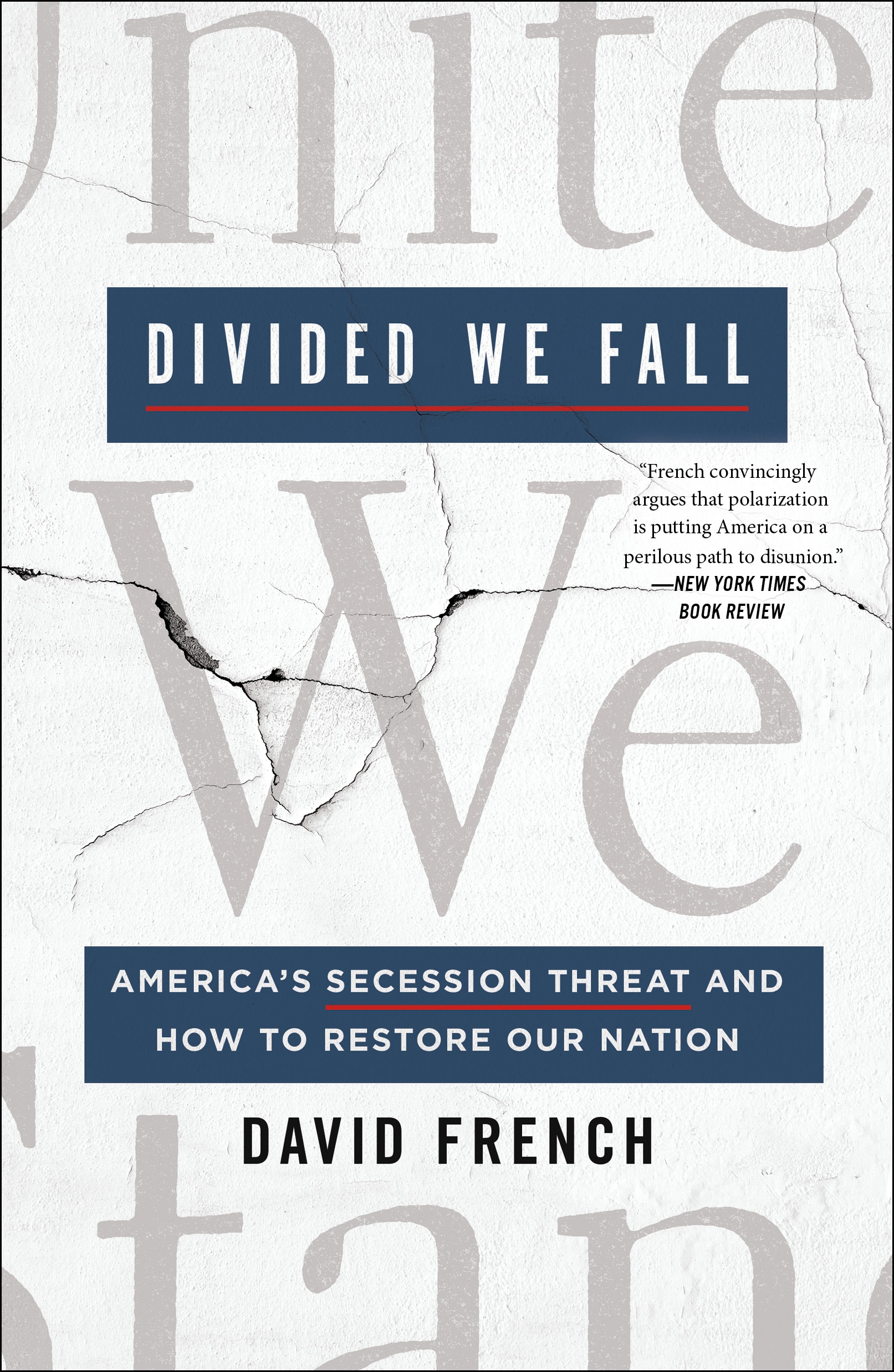
Divided We Fall David French warns of the potential dangers to the country—and the world—if we don’t summon the courage to reconcile our political differences. Two decades into the 21st Century, the U.S. is less united than at any time in our history since the Civil War. We are more diverse in our beliefs and culture than ever before. But red and blue states, secular and religious groups, liberal and conservative idealists, and Republican and Democratic representatives all have one thing in common: each believes their distinct cultures and liberties are being threatened by an escalating violent opposition. This polarized tribalism, espoused by the loudest, angriest fringe extremists on both the left and the right, dismisses dialogue as appeasement; if left unchecked, it could very well lead to secession. An engaging mix of cutting edge research and fair-minded analysis, Divided We Fall is an unblinking look at the true dimensions and dangers of this widening ideological gap, and what could happen if we don't take steps toward bridging it. French reveals chilling, plausible scenarios of how the United States could fracture into regions that will not only weaken the country but destabilize the world. But our future is not written in stone. By implementing James Madison’s vision of pluralism—that all people have the right to form communities representing their personal values—we can prevent oppressive factions from seizing absolute power and instead maintain everyone’s beliefs and identities across all fifty states. Reestablishing national unity will require the bravery to commit ourselves to embracing qualities of kindness, decency, and grace towards those we disagree with ideologically. French calls on all of us to demonstrate true tolerance so we can heal the American divide. If we want to remain united, we must learn to stand together again. POLITICAL SCIENCE,Political Ideologies,Conservatism & Liberalism

Justice on Trial #1 NATIONAL BESTSELLER! Justice Anthony Kennedy slipped out of the Supreme Court building on June 27, 2018, and traveled incognito to the White House to inform President Donald Trump that he was retiring, setting in motion a political process that his successor, Brett Kavanaugh, would denounce three months later as a “national disgrace†and a “circus.†Justice on Trial, the definitive insider’s account of Kavanaugh’s appointment to the Supreme Court, is based on extraordinary access to more than one hundred key figures—including the president, justices, and senators—in that ferocious political drama. The Trump presidency opened with the appointment of Neil Gorsuch to succeed the late Antonin Scalia on the Supreme Court. But the following year, when Trump drew from the same list of candidates for his nomination of Brett Kavanaugh, the justice being replaced was the swing vote on abortion, and all hell broke loose. The judicial confirmation process, on the point of breakdown for thirty years, now proved utterly dysfunctional. Unverified accusations of sexual assault became weapons in a ruthless campaign of personal destruction, culminating in the melodramatic hearings in which Kavanaugh’s impassioned defense resuscitated a nomination that seemed beyond saving. The Supreme Court has become the arbiter of our nation’s most vexing and divisive disputes. With the stakes of each vacancy incalculably high, the incentive to destroy a nominee is nearly irresistible. The next time a nomination promises to change the balance of the Court, Hemingway and Severino warn, the confirmation fight will be even uglier than Kavanaugh’s. A good person might accept that nomination in the naïve belief that what happened to Kavanaugh won’t happen to him because he is a good person. But it can happen, it does happen, and it just happened. The question is whether America will let it happen again. POLITICAL SCIENCE,Political Ideologies,Conservatism & Liberalism
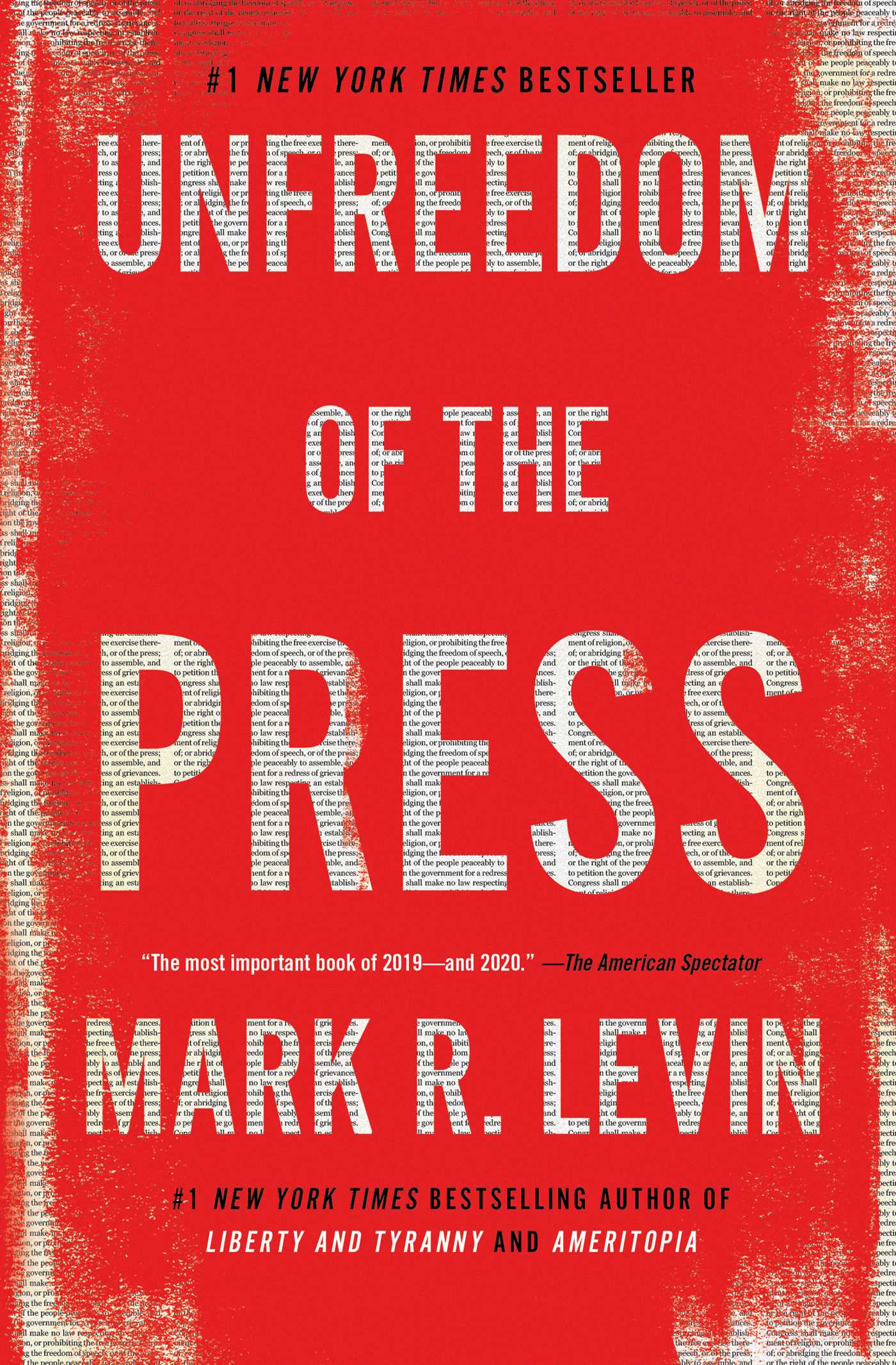
Unfreedom of the Press Six-time New York Times bestselling author, FOX News star, and radio host Mark R. Levin “trounces the news media†(The Washington Times) in this timely and groundbreaking book demonstrating how the great tradition of American free press has degenerated into a standardless profession that has squandered the faith and trust of the public. Unfreedom of the Press is not just another book about the press. In “Levin’s finest work†(Breitbart), he shows how those entrusted with news reporting today are destroying freedom of the press from within—not through actions of government officials, but with its own abandonment of reportorial integrity and objective journalism. With the depth of historical background for which his books are renowned, Levin takes you on a journey through the early American patriot press, which proudly promoted the principles set forth in the Declaration of Independence and the Constitution. This is followed by the early decades of the Republic during which newspapers around the young country were open and transparent about their fierce allegiance to one political party or another. It was only at the start of the Progressive Era and the 20th century that the supposed “objectivity of the press†first surfaced, leaving us where we are today: with a partisan party-press overwhelmingly aligned with a political ideology but hypocritically engaged in a massive untruth as to its real nature. POLITICAL SCIENCE,Political Ideologies,Conservatism & Liberalism

Donald Builds the Wall This hilarious follow-up to 2018's Donald Drains the Swamp continues the story of Donald the Caveman—inspired by you-know-who—as he works tirelessly to save his kingdom by constructing a big, beautiful wall. Written by #1 national bestselling author and humorist Eric Metaxas and illustrated by award-winning artist Tim Raglin, Donald Builds the Wall is the children's book and political parable that America needs right now. POLITICAL SCIENCE,Political Ideologies,Conservatism & Liberalism
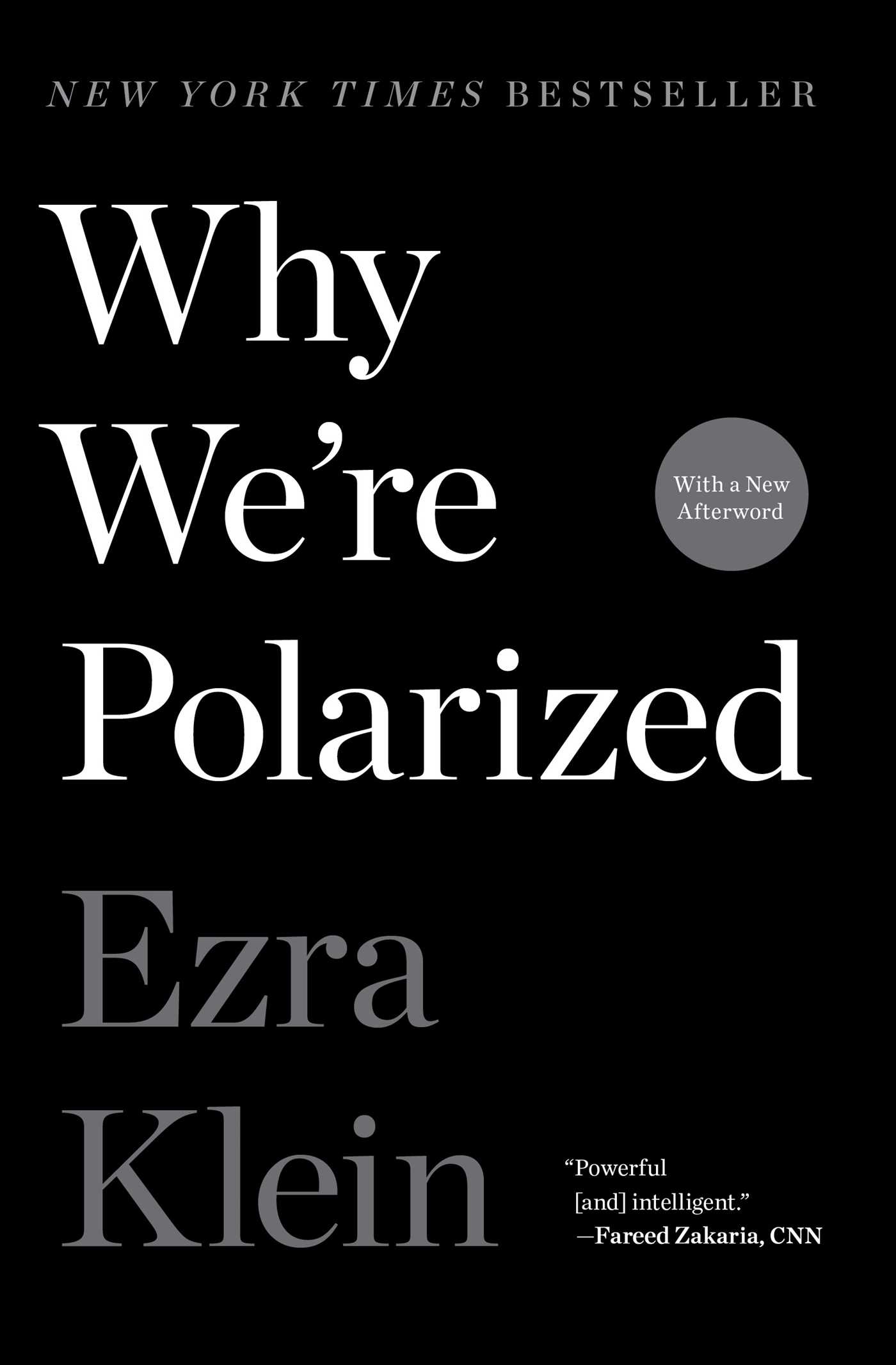
Why We're Polarized This New York Times and Wall Street Journal bestseller shows us that America’s political system isn’t broken. The truth is scarier: it’s working exactly as designed. In this “superbly researched†(The Washington Post) and timely book, journalist Ezra Klein reveals how that system is polarizing us—and how we are polarizing it—with disastrous results. “The American political system—which includes everyone from voters to journalists to the president—is full of rational actors making rational decisions given the incentives they face,†writes political analyst Ezra Klein. “We are a collection of functional parts whose efforts combine into a dysfunctional whole.†“A thoughtful, clear and persuasive analysis†(The New York Times Book Review), Why We’re Polarized reveals the structural and psychological forces behind America’s descent into division and dysfunction. Neither a polemic nor a lament, this book offers a clear framework for understanding everything from Trump’s rise to the Democratic Party’s leftward shift to the politicization of everyday culture. America is polarized, first and foremost, by identity. Everyone engaged in American politics is engaged, at some level, in identity politics. Over the past fifty years in America, our partisan identities have merged with our racial, religious, geographic, ideological, and cultural identities. These merged identities have attained a weight that is breaking much in our politics and tearing at the bonds that hold this country together. Klein shows how and why American politics polarized around identity in the 20th century, and what that polarization did to the way we see the world and one another. And he traces the feedback loops between polarized political identities and polarized political institutions that are driving our system toward crisis. “Well worth reading†(New York magazine), this is an “eye-opening†(O, The Oprah Magazine) book that will change how you look at politics—and perhaps at yourself. POLITICAL SCIENCE,Political Ideologies,Conservatism & Liberalism
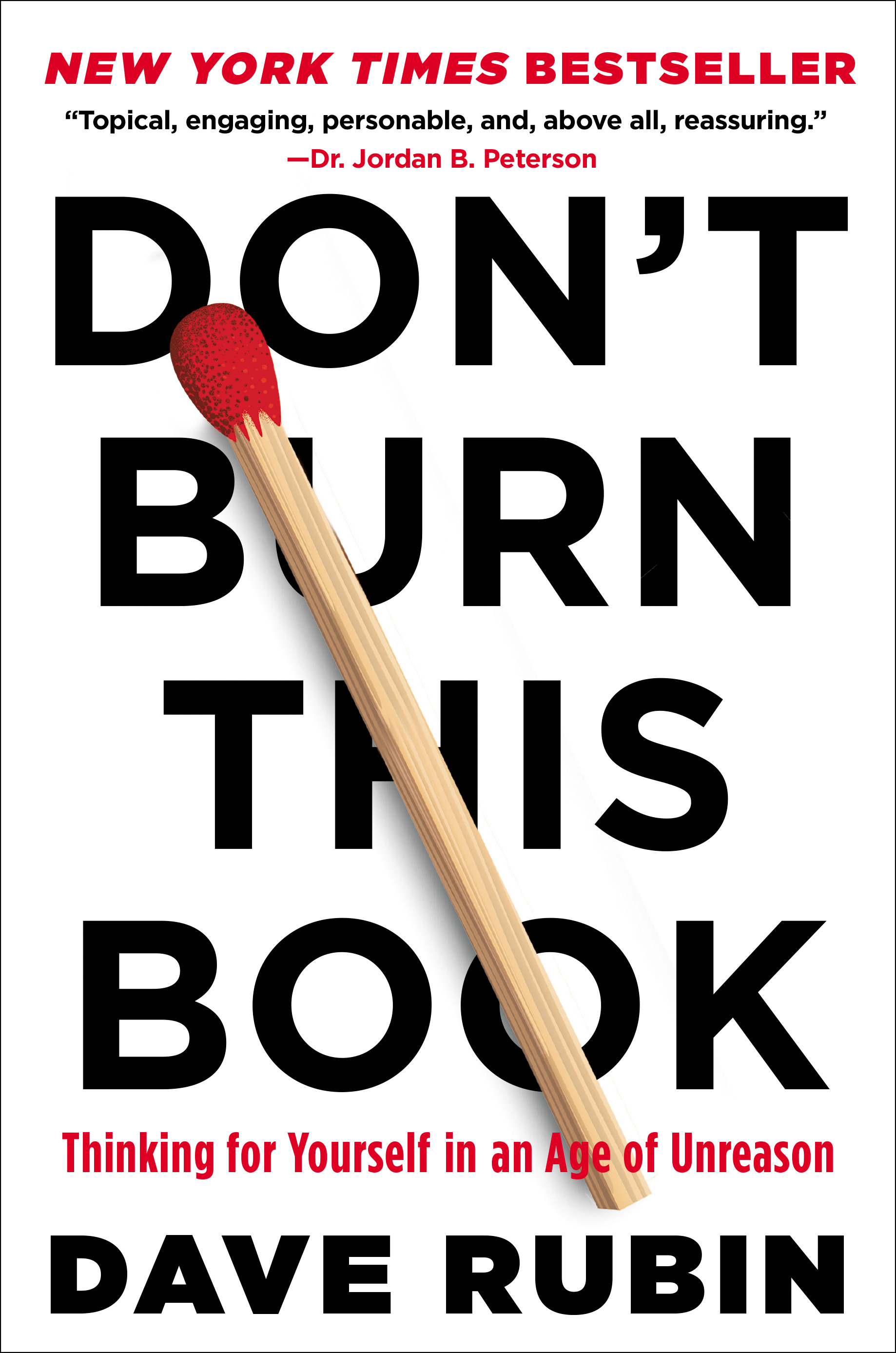
Don't Burn This Book "Topical, engaging, personable, and above all, reassuring." -Dr. Jordan B. Peterson, author of 12 Rules for Life From host of The Rubin Report , the most-watched talk show about free speech and big ideas on YouTube right now, a roadmap for free thinking in an increasingly censored world. The left is no longer liberal. Once on the side of free speech and tolerance, progressives now ban speakers from college campuses, "cancel" people who aren't up to date on the latest genders, and force religious people to violate their conscience. They have abandoned the battle of ideas and have begun fighting a battle of feelings. This uncomfortable truth has turned moderates and true liberals into the politically homeless class. Dave Rubin launched his political talk show The Rubin Report in 2015 as a meeting ground for free thinkers who realize that partisan politics is a dead end. He hosts people he both agrees and disagrees with--including those who have been dismissed, deplatformed, and despised--taking on the most controversial issues of our day. As a result, he's become a voice of reason in a time of madness. Now, Rubin gives you the tools you need to think for yourself in an age when tribal outrage is the only available alternative. Based on his own story as well as his experiences from the front lines of the free speech wars, this book will empower you to make up your own mind about what you believe on any issue and teach you the fine art of: • Checking your facts, not your privilege, when it comes to today's most pervasive myths, from the wage gap and gun violence to climate change and hate crimes. • Standing up to the mob against today's absurd PC culture, when differences of opinion can bring relationships, professional or personal, to a sudden end. • Defending classically liberal principles such as individual rights and limited government, because freedom is impossible without them. The Progressive Woke Machine is waging war against the last free thinkers in the world. Don't Burn This Book is the definitive account of our current political upheaval and your guide to surviving it. POLITICAL SCIENCE,Political Ideologies,Conservatism & Liberalism
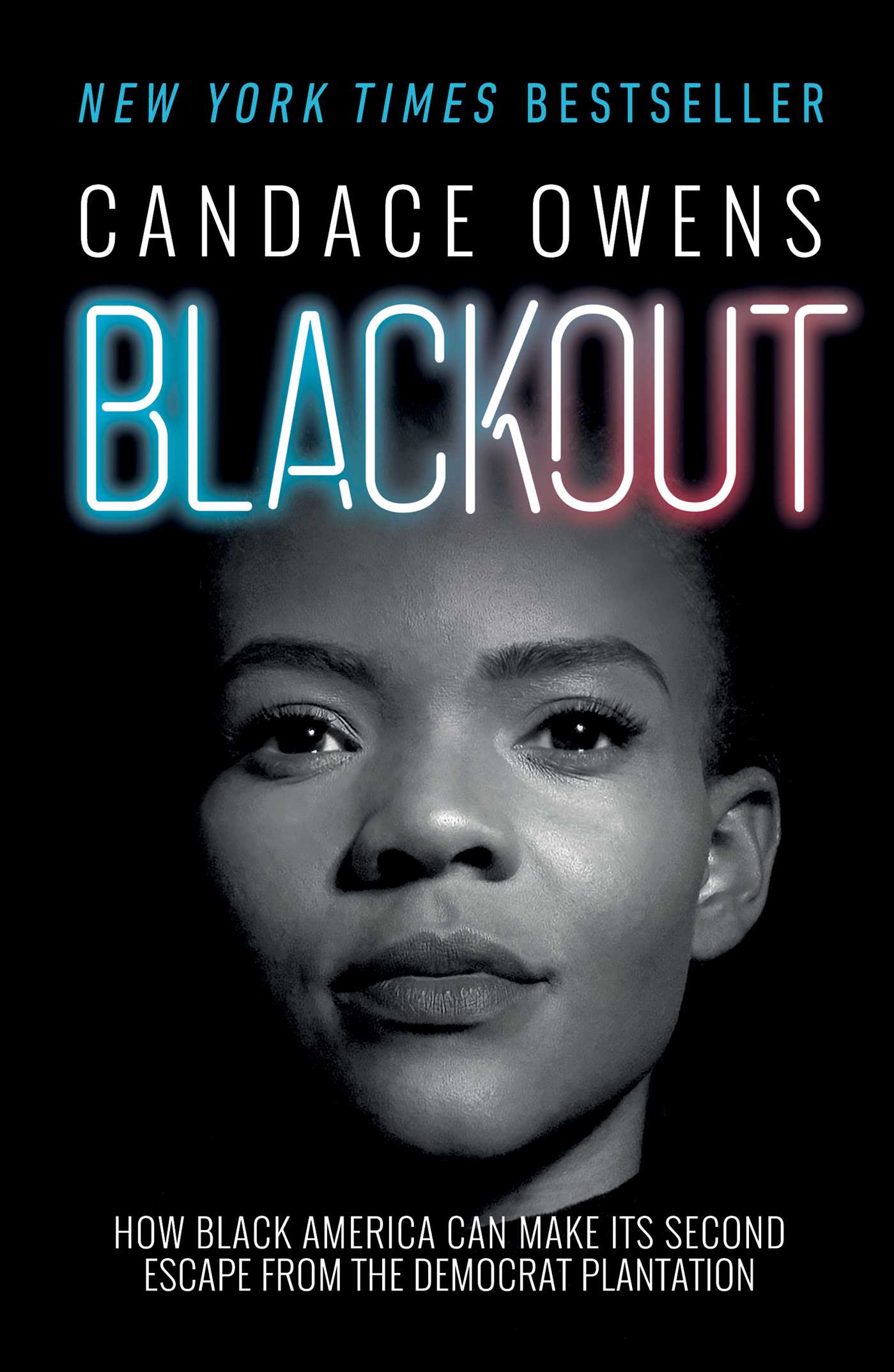
Blackout NEW YORK TIMES BESTSELLER It’s time for a black exit. Political activist and social media star Candace Owens addresses the many ways that Democrat Party policies hurt, rather than help, the African American community, and why she and many others are turning right. Black Americans have long been shackled to the Democrats. Seeing no viable alternative, they have watched liberal politicians take the black vote for granted without pledging anything in return. In Blackout, Owens argues that this automatic allegiance is both illogical and unearned. She contends that the Democrat Party has a long history of racism and exposes the ideals that hinder the black community’s ability to rise above poverty, live independent and successful lives, and be an active part of the American Dream. Instead, Owens offers up a different ideology by issuing a challenge: It’s time for a major black exodus. From dependency, from victimhood, from miseducation—and the Democrat Party, which perpetuates all three. Owens explains that government assistance is a double-edged sword, that the Left dismisses the faith so important to the black community, that Democrat permissiveness toward abortion disproportionately affects black babies, that the #MeToo movement hurts black men, and much more. Weaving in her personal story, which ushered her from a roach-infested low-income apartment to1600 Pennsylvania Avenue, she demonstrates how she overcame her setbacks and challenges despite the cultural expectation that she should embrace a victim mentality. Well-researched and intelligently argued, Blackout lays bare the myth that all black people should vote Democrat—and shows why turning to the right will leave them happier, more successful, and more self-sufficient. POLITICAL SCIENCE,Political Ideologies,Conservatism & Liberalism

Crisis on the Border Idealistic and eager to serve his country, Army Reservist JAG Captain Matt C. Pinsker volunteer to go to Laredo, Texas, for six months as a federal prosecutor, helping out the short-staffed U.S. Attorney's Office. What he saw in Loredo changed his life, and his riveting account of the breakdown of law and order will change how you think about border security. Crisis on the Border reveals: - That drug cartels are in control of the U.S.-Mexican border - The horrifying viciousness of the criminals who smuggle human beings into the United States - That drug abuse and disease are rampant among illegal aliens—many of whom have lengthy criminal records - That routine abuse of the U.S. asylum laws undermines legitimate asylum-seekers - That U.S. courts are generally more lenient with illegal aliens than they would be with American citizens - The hypocrisy behind the "children in cages" stories - Solutions: how to solve the crisis on the border Earnest, shocking, and revealing, Crisis on the Border is essential for understanding one of the greatest problems confronting our country. POLITICAL SCIENCE,Political Ideologies,Conservatism & Liberalism

Irreversible Damage Until just a few years ago, gender dysphoria—severe discomfort in one’s biological sex—was vanishingly rare. It was typically found in less than .01 percent of the population, emerged in early childhood, and afflicted males almost exclusively. But today whole groups of female friends in colleges, high schools, and even middle schools across the country are coming out as “transgender.†These are girls who had never experienced any discomfort in their biological sex until they heard a coming-out story from a speaker at a school assembly or discovered the internet community of trans “influencers.†Unsuspecting parents are awakening to find their daughters in thrall to hip trans YouTube stars and “gender-affirming†educators and therapists who push life-changing interventions on young girls—including medically unnecessary double mastectomies and puberty blockers that can cause permanent infertility. Abigail Shrier, a writer for the Wall Street Journal, has dug deep into the trans epidemic, talking to the girls, their agonized parents, and the counselors and doctors who enable gender transitions, as well as to “detransitionersâ€â€”young women who bitterly regret what they have done to themselves. Coming out as transgender immediately boosts these girls’ social status, Shrier finds, but once they take the first steps of transition, it is not easy to walk back. She offers urgently needed advice about how parents can protect their daughters. A generation of girls is at risk. Abigail Shrier’s essential book will help you understand what the trans craze is and how you can inoculate your child against it—or how to retrieve her from this dangerous path. POLITICAL SCIENCE,Political Ideologies,Conservatism & Liberalism

Above the Law Matthew Whitaker came to Washington to serve as chief of staff to Attorney General Jeff Sessions, and following Sessions’s resignation, he was appointed Acting Attorney General of the United States. A former football player at the University of Iowa who had been confirmed by the Senate as a U.S. Attorney, Whitaker was devoted to the ideals of public service and the rule of law. But what he found when he led the Department of Justice on behalf of President Trump were bureaucratic elites with an agenda all their own. The Department of Justice had been steered off course by a Deep State made up of Washington insiders who saw themselves as above the law. Recklessly inverting, bending, and breaking the law to achieve their own political goals, they relentlessly undermined the Constitution by flaunting the rightful authority of a President they despised. Whitaker was an outsider with a desire to see justice done and democracy work. In his straightforward new book, Above the Law, he provides a stunning account of what he found in the swamp that is Washington. Whitaker reveals: • How former FBI Director James Comey and top figures in the Justice Department openly worked against President Trump • How the Deep State relies on the complicity of the mainstream media to achieve its ends • How the Deep State—drawing on elite universities and corporate law firms—perpetuates itself, keeping a small clique of people in power to ensure that nothing ever changes • How Robert Mueller’s investigation into alleged Russian collusion quickly concluded there was no evidence of wrong- doing by the President or his campaign but nevertheless produced a massive report that was intended as an act of political subversion If you had any doubts that the Deep State actually exists, that it perpetuates a government of insiders, and that it inexorably pursues a political agenda of its own, then you will find Whitaker’s first-person account eye-opening and utterly convincing. POLITICAL SCIENCE,Political Ideologies,Conservatism & Liberalism

For God and Country Donald Trump—Defender of Religious Freedom In 2016, many Christian leaders opposed candidate Donald Trump. He was a social liberal, and his vulgarity, divorces, affairs, and scandals made it impossible for him to defend Christian values in public life. Or so they thought. Trump nevertheless won an overwhelming majority of the Evangelical vote in 2016, as well as the Catholic vote. And in 2020, the idea that he can’t represent Christians is demonstrably false. He has been the most ardent and effective presidential defender of religious liberty and the pro-life cause since Ronald Reagan—whom he has even surpassed in many ways. In For God and Country, Dr. Ralph Reed draws on his deep knowledge of American history, his unsurpassed experience as a political strategist, his personal dealings with President Trump and the First Family, and his moral commitment as a Christian to show why Catholics and Evangelicals should continue to support their unlikely champion. In For God and Country, Reed reveals: The sincerity of President Trump’s Christian faith—and why he has delivered policy victories when other pro-Christian presidents haven’t Why Trump is the most pro-Israel president in American history How liberals hope to demoralize Christians—and thus defeat Donald Trump and reverse his pro-life, pro-family, pro–religious freedom policies Why Never-Trump Christians naively preach de facto political surrender For God and Country is not just required reading for the 2020 election; it is required reading for every conservative Christian who loves America and wants to return it to Christian values. POLITICAL SCIENCE,Political Ideologies,Conservatism & Liberalism

Still Right A leading political analyst navigates an unfamiliar terrain of what it means to be a conservative in the Trump Era in Still Right. Since 2016, “conservative†has come to mean “supportive of the policies of the Trump Administration": building his "wall," enacting ruinous tariffs and limiting trade, alienating our allies and kowtowing to dictators, spending wildly, and generally doing the very opposite of what conservatism actually calls for. As a result, millions of Americans are struggling to reconcile their lifelong political identities with what their traditional political party now stands for. Rick Tyler, MSNBC's leading conservative analyst, shows they are still the ones in the right by making the case for real conservatism, one grounded in principles of liberty, the history of freedom, and simple reason. He explains why it's necessary to have a global view of the economy—and how that includes immigration. He demonstrates the need for protecting our nation with a strong military as well as protecting the planet itself. He discusses what conservatism really asks when it comes to children, healthcare, taxes and elections. In the end he reclaims conservatism for conservatives—and proves that it's the best way forward for America. POLITICAL SCIENCE,Political Ideologies,Conservatism & Liberalism

Uprising “There were these two women, these two beautiful, wonderful women, and I said, ‘Well, let me check it out.’ It took me about two seconds to say, ‘stardom.’†– DONALD J. TRUMP “Diamond and Silk are a national treasure, and their astonishing, heartwarming story is nothing less than an American classic. Get ready to be bowled over.†– MARK LEVIN Who Are Diamond and Silk? Donald Trump’s biggest fans. A national treasure. A force of nature. A political awakening that can’t be stopped. And a natural anti-depressant. Diamond and Silk are all that and more. The very sight and sound of these insightful and ebullient ladies lifts spirits and opens minds. Diamond and Silk are a unique phenomenon impossible to pigeonhole—or to control. And now they tell their own story for the first time. In this account of their amazing journey, told in their own inimitable and irresistible voices, you’ll learn: How the sisters Lynette and Rochelle Hardaway—a.k.a. Diamond and Silk—“were created for such a time as this†How the bridge between their mother’s sharecropping family and their father, a middle-class business owner, shaped their characters Why being “preacher’s kids†was a blessing—and a challenge How working in North Carolina textile plants gave Diamond and Silk early insight into the way NAFTA was hurting Americans and exporting jobs to Mexico Why they supported Donald Trump from the minute he announced his candidacy Why Diamond and Silk will never desert Trump—despite being offered large monetary rewards to switch candidates How social media moguls tried to shut them down and shut them up, lied to them, and gave them the run around How after gaslighting them for 6 months, 29 days, 5 hours, 40 minutes, and 43 seconds, Facebook made the preposterous claim that Diamond and Silk were “unsafe for the community†Practical advice for succeeding the Diamond and Silk way: why “rejection is God’s protection—and redirection†and “your haters make you greater" POLITICAL SCIENCE,Political Ideologies,Conservatism & Liberalism

No Is Not Enough The New York Times–bestselling roadmap to resistance in the Trump era from the internationally acclaimed activist and author of On Fire and The Battle for Paradise. The election of Donald Trump is a dangerous escalation in a world of cascading crises. Trump’s vision—a radical deregulation of the US economy in the interest of corporations, an all-out war on “radical Islamic terrorism,†and a sweeping aside of climate science to unleash a domestic fossil fuel frenzy—will generate wave after wave of crises and shocks, to the economy, to national security, to the environment. In No Is Not Enough, Naomi Klein explains that Trump, extreme as he is, is not an aberration but a logical extension of the worst and most dangerous trends of the past half-century. In exposing the malignant forces behind Trump’s rise, she puts forward a bold vision for a mass movement to counter rising militarism, nationalism, and corporatism in the United States and around the world. Longlisted for the National Book Award “I hope that Klein’s book is read by more than just her (mostly) leftwing fan base. For whatever you think about her economic arguments, she makes a powerful and an important point: that you cannot understand Trump without looking at how he reflects bigger cultural and social dynamics. And what is perhaps refreshing about No Is Not Enough is that Klein tries to move beyond mere outrage and hand-wringing to offer a practical manifesto for opposition.†—Financial Times “Brims with ideas rarely heard in the mainstream media. And her fiery, punchy writing style, which is occasionally laced with humor, makes it hard to put down.†—The Georgia Straight POLITICAL SCIENCE,Political Ideologies,Conservatism & Liberalism

The 21 Biggest Lies about Donald Trump (and you!) Has any president been more unjustly vilified than Donald Trump? Yes, he’s brash. Yes, he has an ego. Yes, his ad-libbing sometimes gets him into trouble. But the fact is Donald Trump is the most effective conservative president in decades. That’s why the media hate him. That’s why they lie about him. And there’s something else. When they lie about him, they’re really lying about you, because to the media, anyone who supports Donald Trump is deplorable. But here, at last, is the counterpunch we’ve been waiting for. Columnist and bestselling author Kurt Schlichter provides a fact-filled—and frequently hilarious—takedown of some of the media’s most pernicious lies about the president. In The 21 Biggest Lies about Donald Trump (and you!), you’ll learn: Why liberals cry “racism†at any argument they don’t like—when the real racists of American history have all been the Democrats How Trump “the warmonger†has actually given America a more realistic—and safer—foreign policy than any of his immediate predecessors Why the media refuses to understand the difference between legal and illegal immigrants (here’s a clue: Trump’s mother was a legal immigrant—and so is his wife) Why Trump and his supporters are infinitely more intelligent than a media that have gotten every major story of the Trump presidency wrong Trump’s great virtues (that too many Republicans lack): realism, courage, common sense, and an unapologetic determination to win conservative victories Tired of media and leftwing lies about Donald Trump? Then you’ll love this book. POLITICAL SCIENCE,Political Ideologies,Conservatism & Liberalism
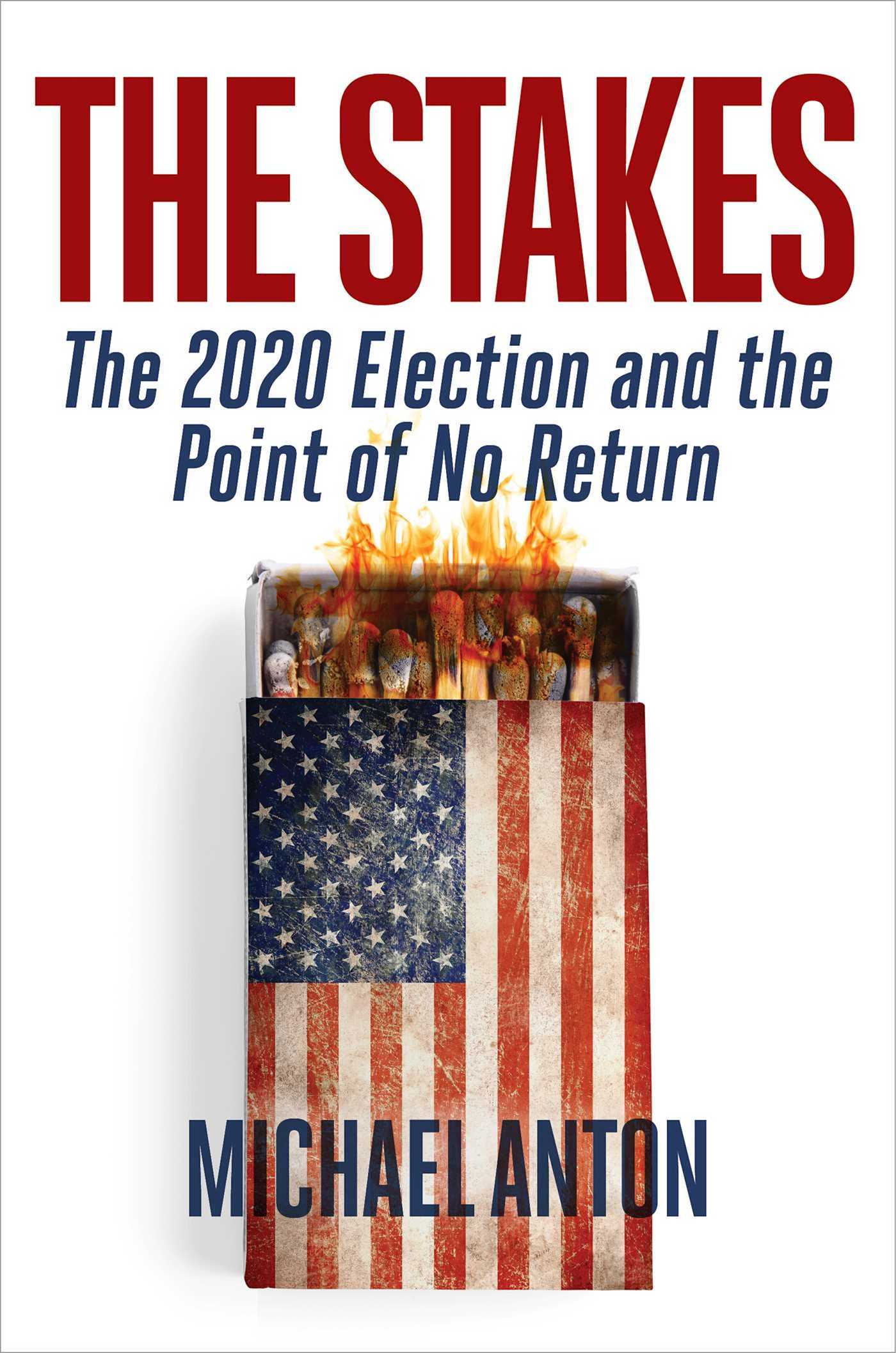
The Stakes Two months before the 2016 presidential election, an anonymously published essay titled "The Flight 93 Election" rallied conservatives to "charge the cockpit" by voting for Trump. Michael Anton, the author of that controversial viral essay, now says that the last few years have only served to prove his "Flight 93" thesis: the left has become more aggressive, more vindictive, and more dangerous—and the stakes have never been higher. To reframe the upcoming 2020 election, Anton looks at California: a state that has descended from a middle-class paradise into crumbling, crowded chaos under unchallenged Democrat rule. Where California goes, so goes the United States of America, Anton argues—unless conservatives take a stand. POLITICAL SCIENCE,Political Ideologies,Conservatism & Liberalism

Abuse and Power The chickens are coming home to roost for the corrupt officials, mainstream media, and Democratic operatives who ruined the life of an innocent American in an attempt to subvert our democracy. Carter Page, the man at the center of one of the worst scandals in our country’s history, reveals how our nation’s top law enforcement officials abused their power and framed an innocent American citizen in their effort to take down Donald Trump. Page’s gripping account, which shows that the rot goes deeper than anyone realized, names the men and women who tried to pull off a coup and didn't care who got hurt. POLITICAL SCIENCE,Political Ideologies,Conservatism & Liberalism
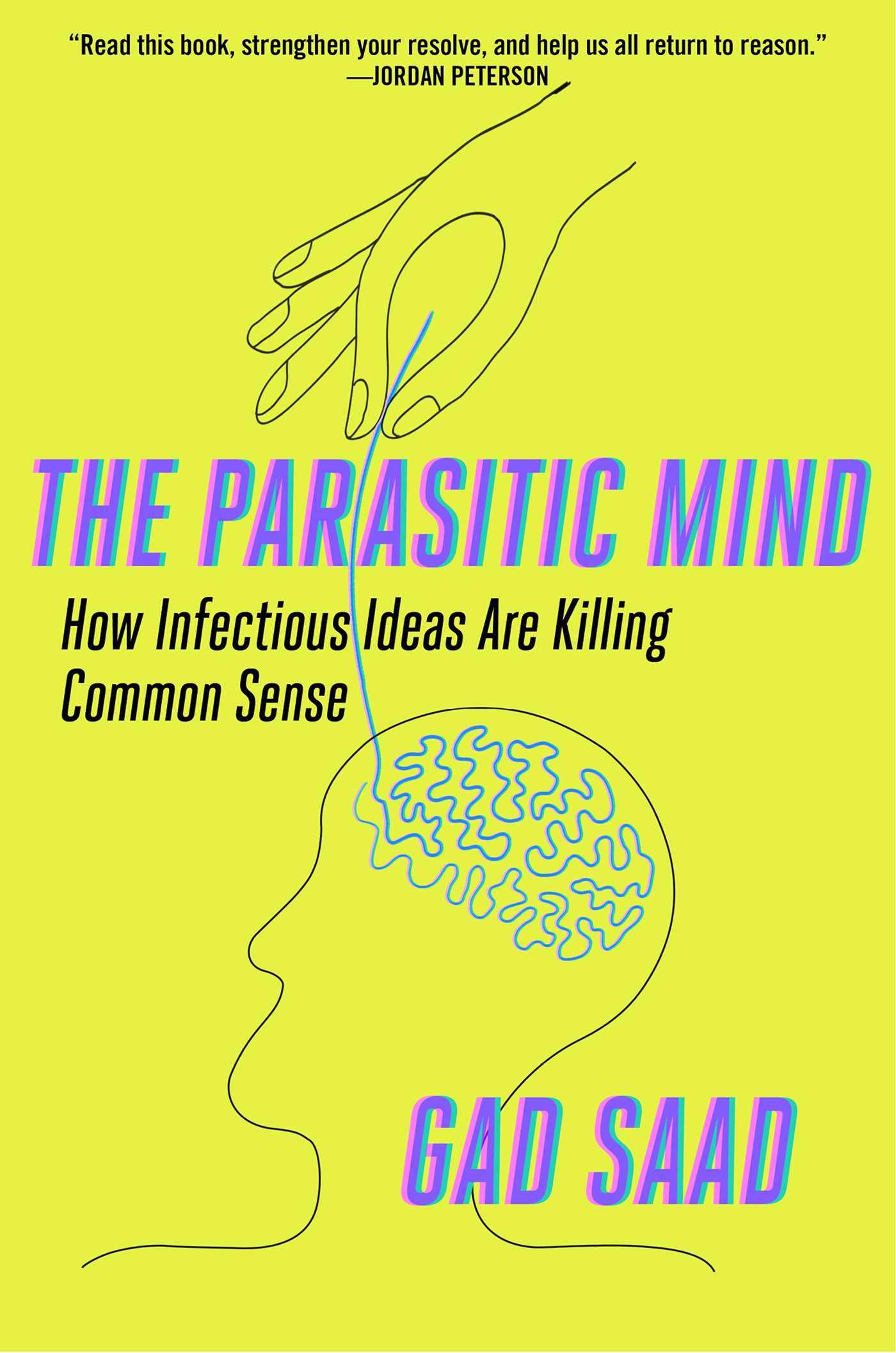
The Parasitic Mind "Read this book, strengthen your resolve, and help us all return to reason." —JORDAN PETERSON The West’s commitment to freedom, reason, and true liberalism have become endangered by a series of viral forces in our society today. Renowned host of the popular YouTube show “The SAAD Truthâ€, Dr. Gad Saad exposes how an epidemic of idea pathogens are spreading like a virus and killing common sense in the West. Serving as a powerful follow-up to Jordan Peterson’s book 12 Rules for Life Dr. Saad unpacks what is really happening in progressive safe zones, why we need to be paying more attention to these trends, and what we must do to stop the spread of dangerous thinking. A professor at Concordia University who has witnessed this troubling epidemic first-hand, Dr. Saad dissects a multitude of these concerning forces (corrupt thought patterns, belief systems, attitudes, etc.) that have given rise to a stifling political correctness in our society and how these have created serious consequences that must be remedied–before it’s too late. POLITICAL SCIENCE,Political Ideologies,Conservatism & Liberalism

Obsession “An electric page-turner that reads like a thriller.†— MOLLIE HEMINGWAY “No prominent journalist covered the story as completely as Byron York. Obsession . . . is a definitive history and a cautionary tale.†– ANDREW C. McCARTHY From the moment Donald Trump was elected president—even before he was inaugurated—Democrats called for his impeachment. That call, starting on the margins of the party and the press, steadily grew until it became a deafening media and Democratic obsession. It culminated first in the Mueller report—which failed to find any evidence of criminal wrongdoing on the part of the president—and then in a failed impeachment. And yet, even now, the Democrats and their media allies insist that President Trump must be guilty of something. They still accuse him of being a Russian stooge and an obstructer of justice. They claim he was “not exonerated†by the Mueller report. But the truth, as veteran reporter Byron York makes clear—using his unequaled access to sources inside Congress and the White House—is that Democrats and the media were gripped by an anti-Trump hysteria that blinded them to reality. In a fast-moving story of real-life Washington intrigue, York reveals: Why Donald Trump—at first—resisted advice to fire FBI director James Comey The strategy behind the Trump defense team’s full cooperation with Mueller’s investigators—and how they felt betrayed by Mueller How the Mueller team knew very early in the investigation that there was no evidence of “Russian collusion†Why the Trump defense team began to suspect that Mueller was not really in charge of the special counsel investigation Why Nancy Pelosi gave up trying to restrain her impeachment-obsessed party Why Trump’s lawyers—certain of his innocence in the Mueller investigation—were even less worried about the Democrats' Ukraine investigation. Byron York takes you inside the deliberations of the president’s defense counsel, interviews congressional Republicans who were shocked at the extremism of their Democratic colleagues—and resolute in opposing them—and draws an unforgettable portrait of an administration under siege from an implacable—and obsessed—opposition party. POLITICAL SCIENCE,Political Ideologies,Conservatism & Liberalism

The Catholic Case for Trump In his compelling new book, The Catholic Case for Trump, Austin Ruse cuts through leftist lies aimed at squashing the Catholic vote and offers his audience – broken down into three categories of Liberal, Faithful, and Generic Catholics – a guide as to why all Catholics should not only vote for President Trump, but do so enthusiastically with confidence that he is the only moral choice. This book examines more than a dozen issues and makes the case that a Faithful Catholic can find not just a reason, but a Catholic reason, to vote for Trump. This is a must-read book for all Catholic voters. POLITICAL SCIENCE,Political Ideologies,Conservatism & Liberalism

Supreme Disorder Politics have always intruded on Supreme Court appointments. But although the Framers would recognize the way justices are nominated and confirmed today, something is different. Why have appointments to the high court become one of the most explosive features of our system of government? As Ilya Shapiro makes clear in Supreme Disorder, this problem is part of a larger phenomenon. As government has grown, its laws reaching even further into our lives, the courts that interpret those laws have become enormously powerful. If we fight over each new appointment as though everything were at stake, it’s because it is. When decades of constitutional corruption have left us subject to an all-powerful tribunal, passions are sure to flare on the infrequent occasions when the political system has an opportunity to shape it. And so we find the process of judicial appointments verging on dysfunction. Shapiro weighs the many proposals for reform, from the modest (term limits) to the radical (court-packing), but shows that there can be no quick fix for a judicial system suffering a crisis of legitimacy. And in the end, the only measure of the Court’s legitimacy that matters is the extent to which it maintains, or rebalances, our constitutional order. POLITICAL SCIENCE,Political Ideologies,Conservatism & Liberalism
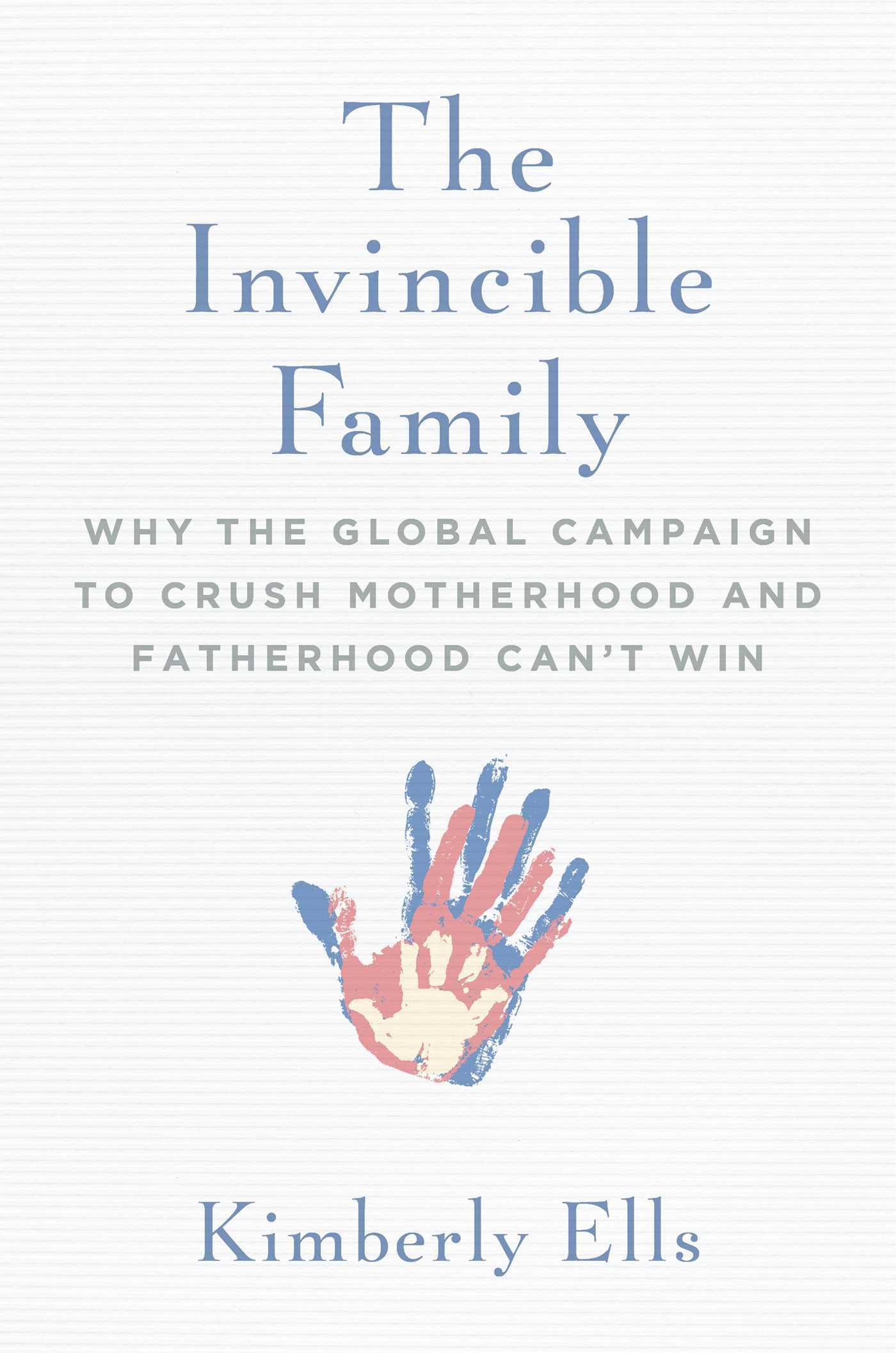
The Invincible Family The Fight for the Family Socialists and feminists have long targeted the family as an enemy, even the enemy. For socialists, the family is an obstacle to the full power of the progressive state. For feminists, the family denies female independence and equality. Today, however, the battle has grown even fiercer, as socialists and feminists have found a global ally in the United Nations, which is using its extraordinary power to undercut the authority and the sanctity of the family around the world—even in the United States. International policy advisor Kimberly Ells exposes this unholy alliance between globalist liberals, feminists, and socialists, and unveils the shocking harm being done, right now, to women and children in America and around the world. In The Invincible Family you’ll learn: -How, in the name of “equality,†women are actually losing what should be inherent rights -How “science†is being intentionally perverted to advance an entirely unscientific agenda -Why the globalization of anti-family policies is a direct threat to our own families in the United States -Why there is still hope that the unholy alliance of feminists, socialists, and liberals can be defeated The Invincible Family is a shocking and essential report on how your family could be threatened— and what you and all concerned citizens can do to defend the institution of the family and our inherent human rights. POLITICAL SCIENCE,Political Ideologies,Conservatism & Liberalism

The Biden Deception “I have the most progressive record of anybody running.†If you want to know how far-left a Joe Biden presidency would be, you need look no further than his own words. His rhetoric may not be as fiery as that of Bernie Sanders, but make no mistake: he holds essentially the same policy positions. Bestselling author and former Hoover Institute fellow George Neumayr lays out the truth the media won’t tell you: that Blue-collar Joe disappeared decades ago. He is far more comfortable on the Ellen show than on the streets of Scranton. He has given up Amtrak for private jets, and, like his lobbyist brother and grifter son, has cashed in on his last name. While the media and Democrat establishment—eager to dupe independents and Never-Trump Republicans—spin talking points to paint Biden as the moderate and lovable “Uncle Joeâ€, the reality is a Biden presidency threatens to return America to the disastrous and radical left-wing politics and policies of the Obama era. POLITICAL SCIENCE,Political Ideologies,Conservatism & Liberalism
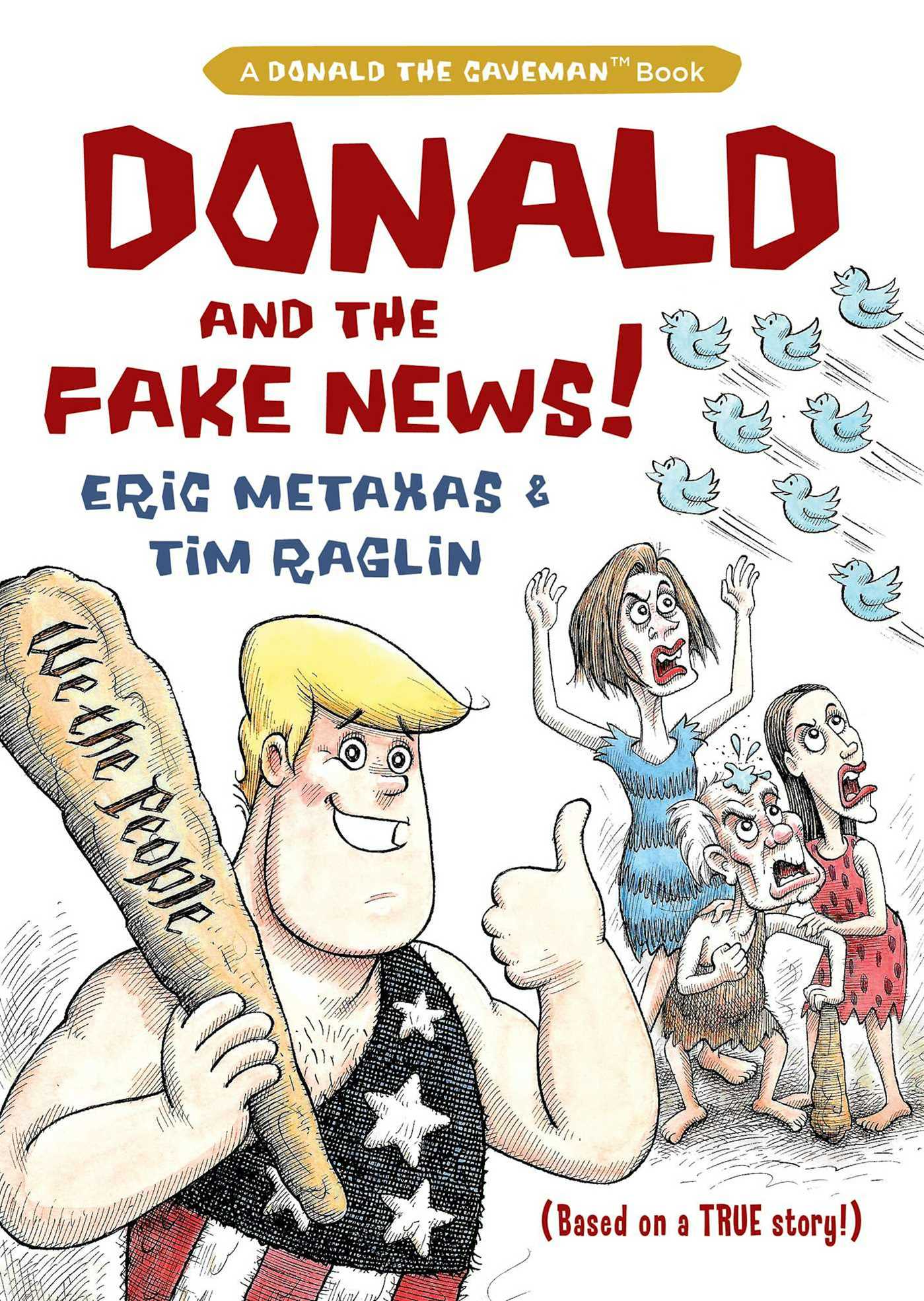
Donald and the Fake News After Donald the Caveman drained the Swamp and built the Wall, everyone was happy! Everyone, that is, except the freedom-haters who called themselves “The Resistance.†Led by an evil sorceress named Madame Miss Speaker, the Resistance tried to contradict everything Donald said to make him seem like a bad leader. These troublemakers even used Fake News to spread the rumor that Donald was working for the Russians! But Donald was not discouraged—he knew just what to do. He fought back with the truth. And the truth will always defeat Fake News. THE TRUTH WILL ALWAYS WIN OUT OVER FAKE NEWS!!! Written by national #1 bestselling author and humorist Eric Metaxas and illustrated by award winning artist Tim Raglin, Donald and the Fake News continues the brilliant political parable that began with Donald Drains the Swamp and Donald Builds the Wall. POLITICAL SCIENCE,Political Ideologies,Conservatism & Liberalism

Conservatism A fresh and sharp-eyed history of political conservatism from its nineteenth-century origins to today’s hard Right For two hundred years, conservatism has defied its reputation as a backward-looking creed by confronting and adapting to liberal modernity. By doing so, the Right has won long periods of power and effectively become the dominant tradition in politics. Yet, despite their success, conservatives have continued to fight with each other about how far to compromise with liberalism and democracy—or which values to defend and how. In Conservatism, Edmund Fawcett provides a gripping account of this conflicted history, clarifies key ideas, and illuminates quarrels within the Right today. Focusing on the United States, Britain, France, and Germany, Fawcett’s vivid narrative covers thinkers and politicians. They include the forerunners James Madison, Edmund Burke, and Joseph de Maistre; early friends and foes of capitalism; defenders of religion; and builders of modern parties, such as William McKinley and Lord Salisbury. The book chronicles the cultural critics and radical disruptors of the 1920s and 1930s, recounts how advocates of laissez-faire economics broke the post 1945 consensus, and describes how Donald Trump, Boris Johnson, and their European counterparts are pushing conservatism toward a nation-first, hard Right. An absorbing, original history of the Right, Conservatism portrays a tradition as much at war with itself as with its opponents. POLITICAL SCIENCE,Political Ideologies,Conservatism & Liberalism

The Case for Liberalism in an Age of Extremism “Maybe the question isn’t what happened to Alan Dershowitz. Maybe it’s what happened to everyone else.â€â€”Politico In The Case for Liberalism in an Age of Extremism, Alan Dershowitz—New York Times bestselling author and one of America’s most respected legal scholars—makes a classical liberal argument for centrist government in the US, as the Founding Fathers and the Constitution intended. Alan Dershowitz has been called “one of the most prominent and consistent defenders of civil liberties in America†by Politico and “the nation’s most peripatetic civil liberties lawyer and one of its most distinguished defenders of individual rights†by Newsweek. Yet he has come under intense criticism for his consistent classical liberalism in the face of a rapidly polarizing political landscape and for his steadfast support of centrist governance over either “progressive†or reactionary radicalism. The Case for Liberalism in an Age of Extremism is a defense of liberalism and its renewed relevance today. It makes the case for classic liberal values and programs over radical-left and reactionary right-wing agendas, and for centrism over extremism in general, showing why the United States has thrived throughout history because of its enduringly centrist base. It seeks to restore contemporary liberalism to its important place in the American political landscape, and attempts to persuade centrists from both the left and right—who may today call themselves progressives or moderate conservatives—that they, too, belong in the big tent of centrist liberalism. As a professor for half a century, Dershowitz never told students what values to accept or which candidates to support, but helped guide them to conclusions based on their own sets of values. He does the same in this book. A guide for all readers, rather than a piece of political advocacy for one party or another, The Case for Liberalism in an Age of Extremism is Alan Dershowitz’s argument for classical liberal values and their role in forming just societies and protecting against the dangers of extremism, just as they must today. It is essential reading for anyone interested in or concerned about political polarization on both the far-right and -left, and for everyone seeking a middle path between the extremes. POLITICAL SCIENCE,Political Ideologies,Conservatism & Liberalism

The Gilded Rage A grippingly intimate and heart-breaking portrait of the walking wounded who make up the base of the Trump movement. Desperate and angry, these are the men and women of the vanishing industrial heartland and the depressed Appalachian coal country and the drug-running, no-man's land along the Southwestern borderlands. They have no illusions about the grandstanding billionaire and his glaring flaws. But they feel forgotten and screwed over by the political, corporate and media elites...and they feel that Donald Trump, despite his flamboyant demagoguery, might well be their last chance for salvation. Part Studs Terkel, part Hunter Thompson, Alexander Zaitchik takes us deeper into the ravaged soul of America than any other chronicler of our times. POLITICAL SCIENCE,Political Ideologies,Conservatism & Liberalism

In Search of European Liberalisms Since the Enlightenment, liberalism as a concept has been foundational for European identity and politics, even as it has been increasingly interrogated and contested. This comprehensive study takes a fresh look at the diverse understandings and interpretations of the idea of liberalism in Europe, encompassing not just the familiar movements, doctrines, and political parties that fall under the heading of “liberal†but also the intertwined historical currents of thought behind them. Here we find not an abstract, universalized liberalism, but a complex and overlapping configuration of liberalisms tied to diverse linguistic, temporal, and political contexts. POLITICAL SCIENCE,Political Ideologies,Conservatism & Liberalism

Liberalism in Practice An argument that draws on empirical findings in psychology to offer a blueprint for cultivating a widespread commitment to public reason. At the core of liberal theory is the idea—found in thinkers from Hobbes to Rawls—that the consent of the governed is key to establishing political legitimacy. But in a diverse liberal polity like the United States, disagreement runs deep, and a segment of the population will simply regard the regime as illegitimate. In Liberalism in Practice, Olivia Newman argues that if citizens were to approach politics in the spirit of public reason, couching arguments in terms that others can reasonably accept, institutional and political legitimacy would be enhanced. Liberal theory has relied on the assumption of a unified self, that individuals are unified around a single set of goals, beliefs, attitudes, and aptitudes. Drawing on empirical findings in psychology, Newman argues instead that we are complex creatures whose dispositions and traits develop differently in different domains; we hold different moral commitments in different parts of our lives. She argues further that this domain differentiation allows us to be good liberal citizens in the public domain while remaining true to private commitments and beliefs in other domains. Newman proposes that educational and institutional arrangements can use this capacity for differentiation to teach public reason without overwhelming conflicting commitments. The psychology and pedagogy of public reason proposed by Newman move beyond John Rawls's strictly political liberalism toward what Newman terms practical liberalism. Although we cannot resolve every philosophical problem bedeviling theories of liberalism, we can enjoy the myriad benefits of liberalism in practice. POLITICAL SCIENCE,Political Ideologies,Conservatism & Liberalism
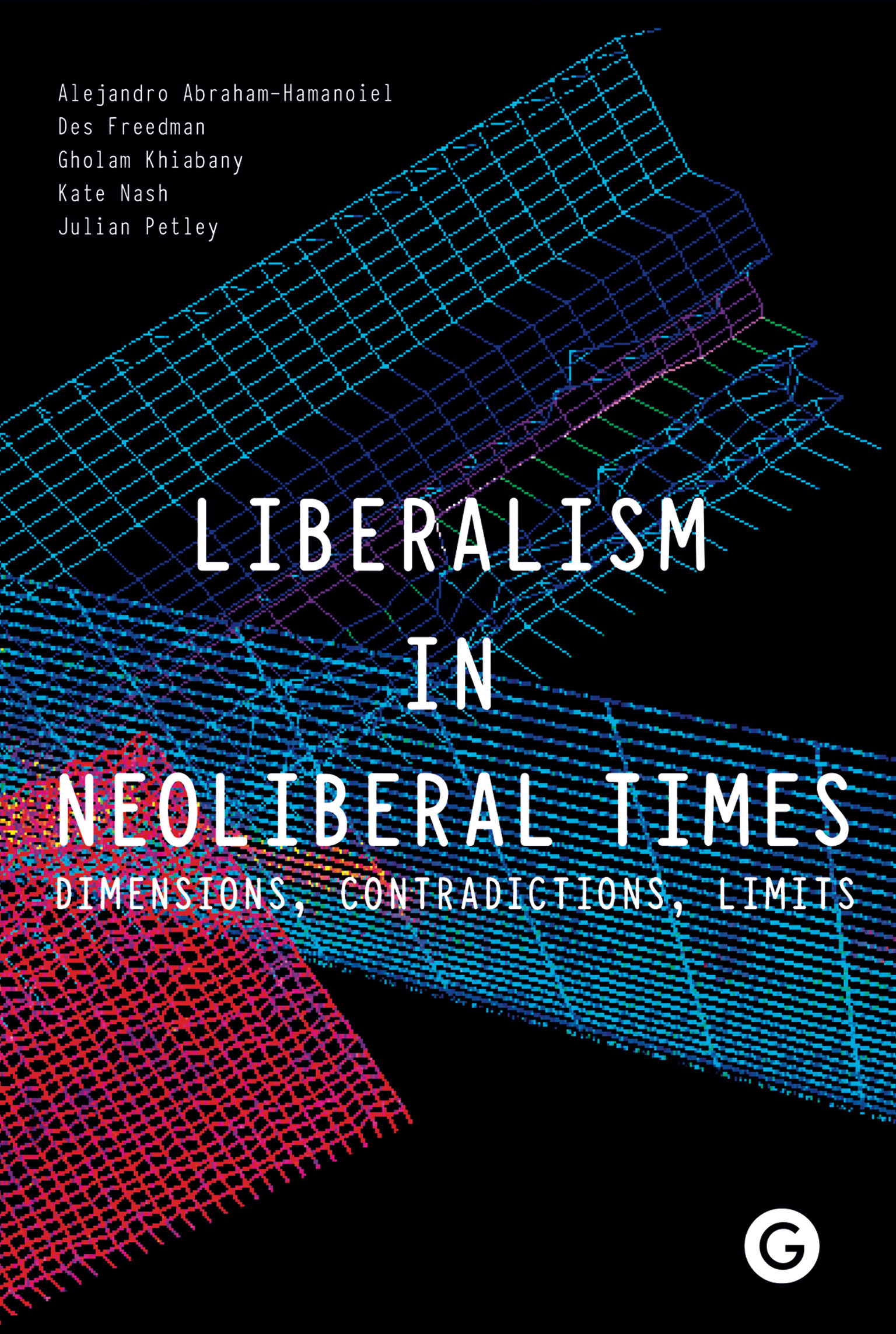
Liberalism in Neoliberal Times An exploration of the theories, histories, practices, and contradictions of liberalism today. What does it mean to be a liberal in neoliberal times? This collection of short essays attempts to show how liberals and the wider concept of liberalism remain relevant in what many perceive to be a highly illiberal age. Liberalism in the broader sense revolves around tolerance, progress, humanitarianism, objectivity, reason, democracy, and human rights. Liberalism's emphasis on individual rights opened a theoretical pathway to neoliberalism, through private property, a classically minimal liberal state, and the efficiency of “free markets.” In practice, neoliberalism is associated less with the economic deregulation championed by its advocates than the re-regulation of the economy to protect financial capital. Liberalism in Neoliberal Times engages with the theories, histories, practices, and contradictions of liberalism, viewing it in relation to four central areas of public life: human rights, ethnicity and gender, education, and the media. The contributors explore the transformations in as well as the transformative aspects of liberalism and highlight both its liberating and limiting capacities. The book contends that liberalism—in all its forms—continues to underpin specific institutions such as the university, the free press, the courts, and, of course, parliamentary democracy. Liberal ideas are regularly mobilized in areas such as counterterrorism, minority rights, privacy, and the pursuit of knowledge. This book contends that while we may not agree on much, we can certainly agree that an understanding of liberalism and its emancipatory capacity is simply too important to be left to the liberals Contributors Alejandro Abraham-Hamanoiel, Patrick Ainley, Abdullahi An-Na'im, Michael Bailey, Haim Bresheeth, Başak Çalı, David Chandler, William Davies, Costas Douzinas, Natalie Fenton, Des Freedman, Roberto Gargarella, Priyamvada Gopal, Jonathan Hardy, John Holmwood, Ratna Kapur, Gholam Khiabany, Ray Kiely, Monika Krause, Deepa Kumar, Arun Kundnani, Colin Leys, Howard Littler, Kathleen Lynch, Robert W. McChesney, Nivedita Menon, Toby Miller, Kate Nash, Joan Pedro-Carañana, Julian Petley, Anne Phillips, Jonathan Rosenhead, Annabelle Sreberny, John Steel, Michael Wayne, Milly Williamson POLITICAL SCIENCE,Political Ideologies,Conservatism & Liberalism
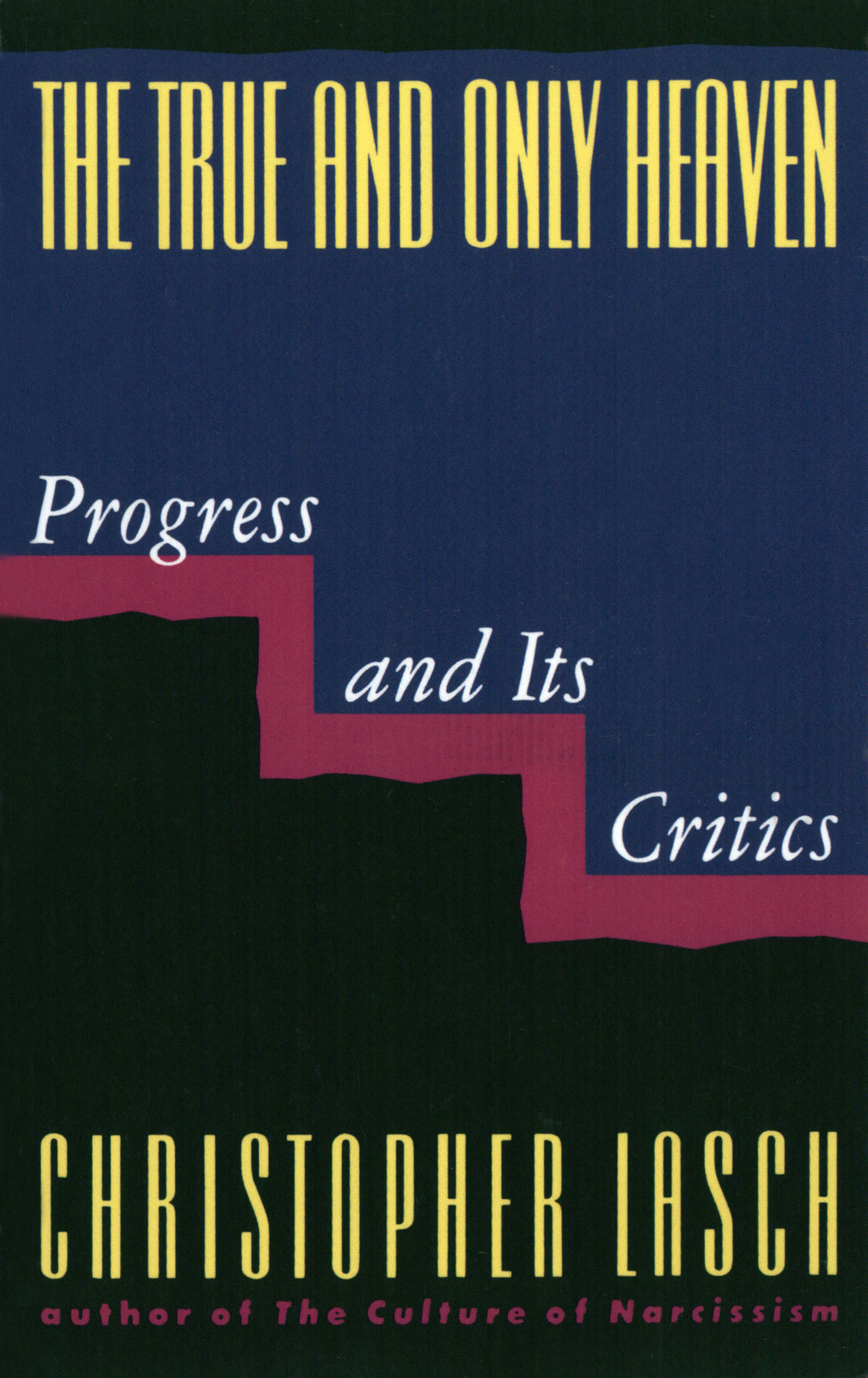
The True and Only Heaven "A major and challenging work. . . . Provocative, and certain to be controversial. . . . Will add important new dimension to the continuing debate on the decline of liberalism." —William Julius Wilson, New York Times Book Review Can we continue to believe in progress? In this sobering analysis of the Western human condition, Christopher Lasch seeks the answer in a history of the struggle between two ideas: one is the idea of progress - an idea driven by the conviction that human desire is insatiable and requires ever larger production forces. Opposing this materialist view is the idea that condemns a boundless appetite for more and better goods and distrusts "improvements" that only feed desire. Tracing the opposition to the idea of progress from Rousseau through Montesquieu to Carlyle, Max Weber and G.D.H. Cole, Lasch finds much that is desirable in a turn toward moral conservatism, toward a lower-middle-class culture that features egalitarianism, workmanship and loyalty, and recognizes the danger of resentment of the material goods of others. POLITICAL SCIENCE,Political Ideologies,Conservatism & Liberalism

The Stakes To save both democracy and a decent economy, here’s why it’s crucial that Americans elect a truly progressive president. The 2020 presidential election will determine the very survival of American democracy. To restore popular faith in government—and win the election—Democrats need to nominate and elect an economic progressive. The Stakes explains how the failure of the economy to serve ordinary Americans opened the door to a demagogic president, and how democracy can still be taken back from Donald Trump. Either the United States continues the long slide into the arms of the bankers and corporate interests and the disaffection of working Americans—the course set in the past half century by Republican and Democratic presidents alike—or we elect a progressive Democrat in the mold of FDR. At stake is nothing less than the continued success of the American experiment in liberal democracy. That success is dependent on a fairer distribution of income, wealth, and life changes —and a reduction in the political influence of financial elites over both parties. The decay of democracy and economic fairness began long before Trump. The American republic is in need of a massive overhaul. It will take not just a resounding Democratic victory in 2020 but a progressive victory to pull back from the brink of autocracy. The Stakes demonstrates how a progressive Democrat has a better chance than a centrist of winning the presidency, and how only this outcome can begin the renewal of the economy and our democracy. A passionate book from one of America’s best political analysts, The Stakes is the book to read ahead of the 2020 primaries and general election. POLITICAL SCIENCE,Political Ideologies,Conservatism & Liberalism

Family Values Why was the discourse of family values so pivotal to the conservative and free-market revolution of the 1980s and why has it continued to exert such a profound influence on American political life? Why have free-market neoliberals so often made common cause with social conservatives on the question of family, despite their differences on all other issues? In this book, Melinda Cooper challenges the idea that neoliberalism privileges atomized individualism over familial solidarities, and contractual freedom over inherited status. Delving into the history of the American poor laws, she shows how the liberal ethos of personal responsibility was always undergirded by a wider imperative of family responsibility and how this investment in kinship obligations recurrently facilitated the working relationship between free-market liberals and social conservatives. Neoliberalism, she argues, must be understood as an effort to revive and extend the poor law tradition in the contemporary idiom of household debt. As neoliberal policymakers imposed cuts to health, education, and welfare budgets, they simultaneously identified the family as a wholesale alternative to the twentieth-century welfare state. And as the responsibility for deficit spending shifted from the state to the household, the private debt obligations of family were defined as foundational to socio-economic order. Despite their differences, neoliberals and social conservatives were in agreement that the bonds of family needed to be encouraged — and at the limit enforced — as a necessary counterpart to market freedom. In a series of case studies ranging from Clinton’s welfare reform to the AIDS epidemic, and from same-sex marriage to the student loan crisis, Cooper explores the key policy contributions made by neoliberal economists and legal theorists. Only by restoring the question of family to its central place in the neoliberal project, she argues, can we make sense of the defining political alliance of our times, that between free-market economics and social conservatism. POLITICAL SCIENCE,Political Ideologies,Conservatism & Liberalism
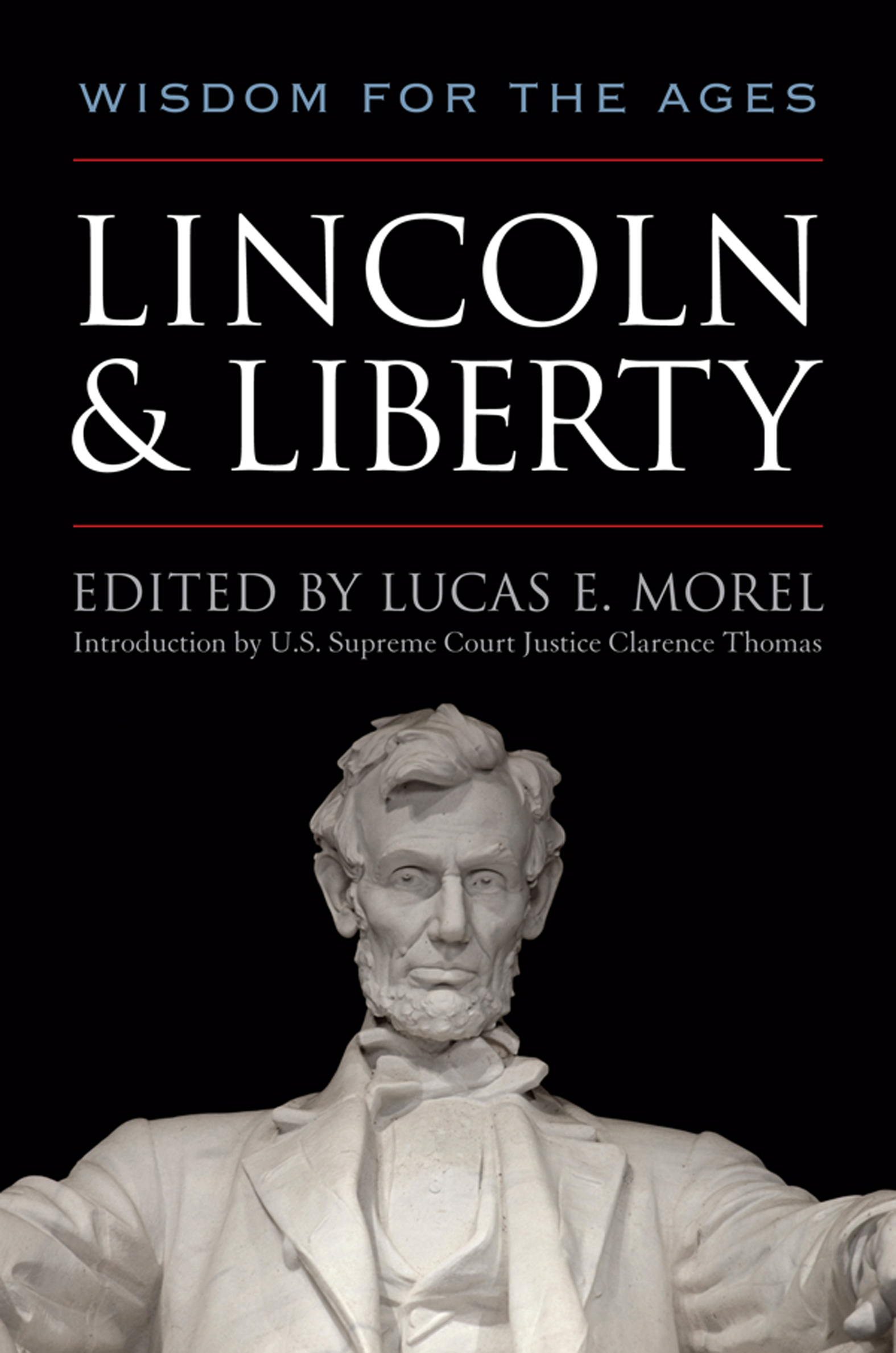
Lincoln & Liberty Since Abraham Lincoln's death, generations of Americans have studied his life, presidency, and leadership, often remaking him into a figure suited to the needs and interests of their own time. This illuminating volume takes a different approach to his political thought and practice. Here, a distinguished group of contributors argue that Lincoln's relevance today is best expressed by rendering an accurate portrait of him in his own era. They seek to understand Lincoln as he understood himself and as he attempted to make his ideas clear to his contemporaries. What emerges is a portrait of a prudent leader who is driven to return the country to its original principles in order to conserve it. The contributors demonstrate that, far from advocating an expansion of government beyond its constitutional limits, Lincoln defended both the Declaration of Independence and the Constitution. In his introduction, Justice Clarence Thomas discusses how Lincoln used the ideological and structural underpinnings of those founding documents to defeat slavery and secure the liberties that the Republic was established to protect. Other chapters reveal how Lincoln upheld the principle of limited government even as he employed unprecedented war powers. Featuring contributions from leading scholars such as Michael Burlingame, Allen C. Guelzo, Fred Kaplan, and Matthew Pinsker, this innovative collection presents fresh perspectives on Lincoln both as a political thinker and a practical politician. Taken together, these essays decisively demonstrate that the most iconic American president still has much to teach the modern-day student of politics. POLITICAL SCIENCE,Political Ideologies,Conservatism & Liberalism
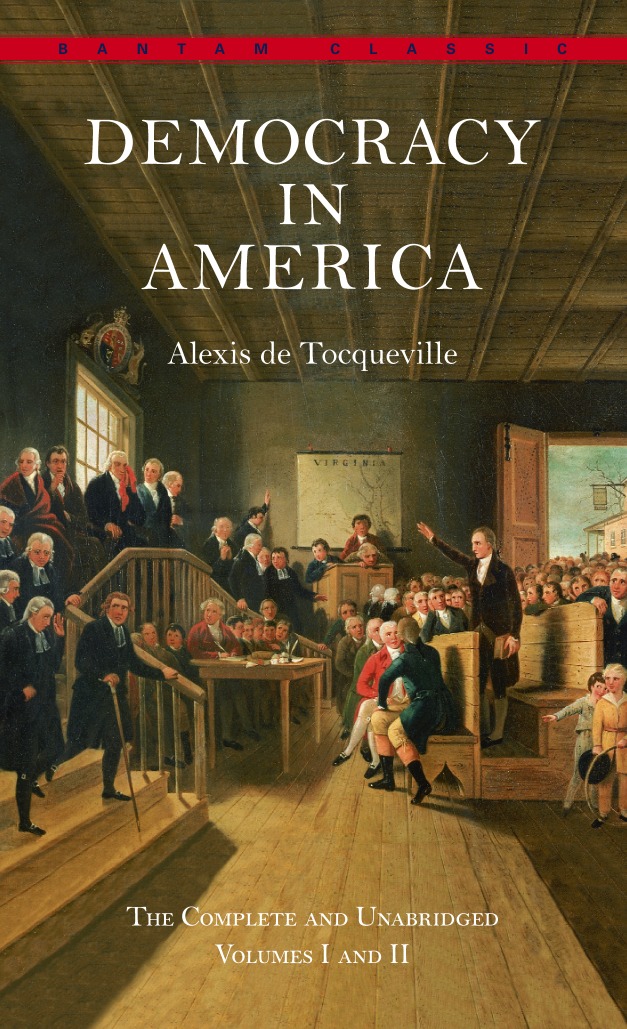
Democracy in America From America's call for a free press to its embrace of the capitalist system, Democracy in America--first published in 1835--enlightens, entertains, and endures as a brilliant study of our national government and character. Philosopher John Stuart Mill called it "among the most remarkable productions of our time." Woodrow Wilson wrote that de Tocqueville's ability to illuminate the actual workings of American democracy was "possibly without rival." For today's readers, de Tocqueville's concern about the effect of majority rule on the rights of individuals remains deeply meaningful. His shrewd observations about the "almost royal prerogatives" of the president and the need for virtue in elected officials are particularly prophetic. His profound insights into the great rewards and responsibilities of democratic government are words every American needs to read, contemplate, and remember. From America's call for a free press to its embrace of the capitalist system Democracy in America enlightens, entertains, and endures as a brilliant study of our national government and character. De Toqueville's concern about the effect of majority rule on the rights of individuals remains deeply meaningful. His insights into the great rewards and responsibilities of democratic government are words every American needs to read, contemplate, and remember. POLITICAL SCIENCE,Political Ideologies,Democracy
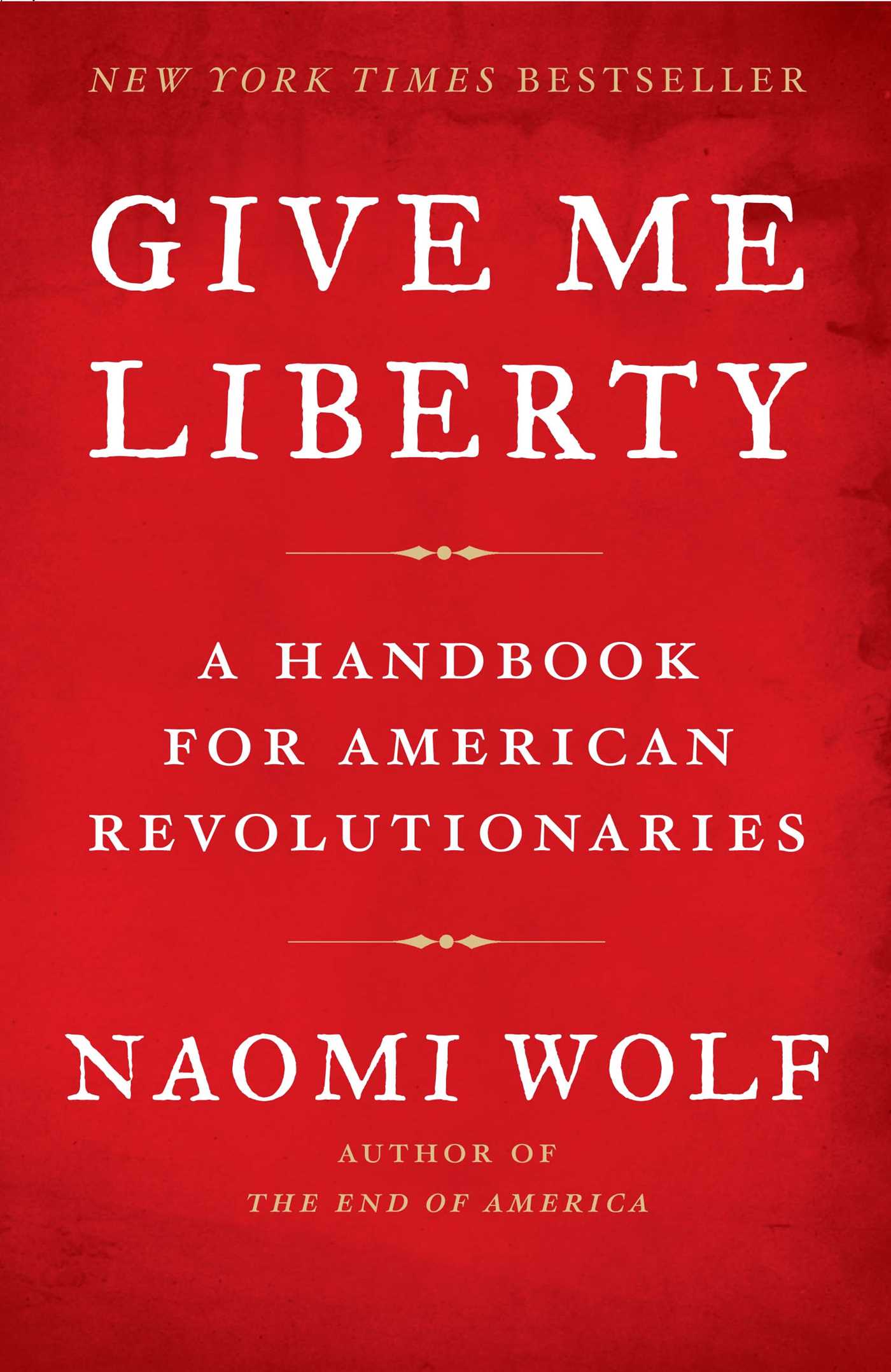
Give Me Liberty As the practice of democracy becomes a lost art, Americans are increasingly desperate for a restored nation. Many have a general sense that the "system" is in disorder -- if not on the road to functional collapse. But though it is easy to identify our political problems, the solutions are not always as clear. In Give Me Liberty: A Handbook for American Revolutionaries, bestselling author Naomi Wolf illustrates the breathtaking changes that can take place when ordinary citizens engage in the democratic system the way the founders intended and tells how to use that system, right now, to change your life, your community, and ultimately, the nation. POLITICAL SCIENCE,Political Ideologies,Democracy
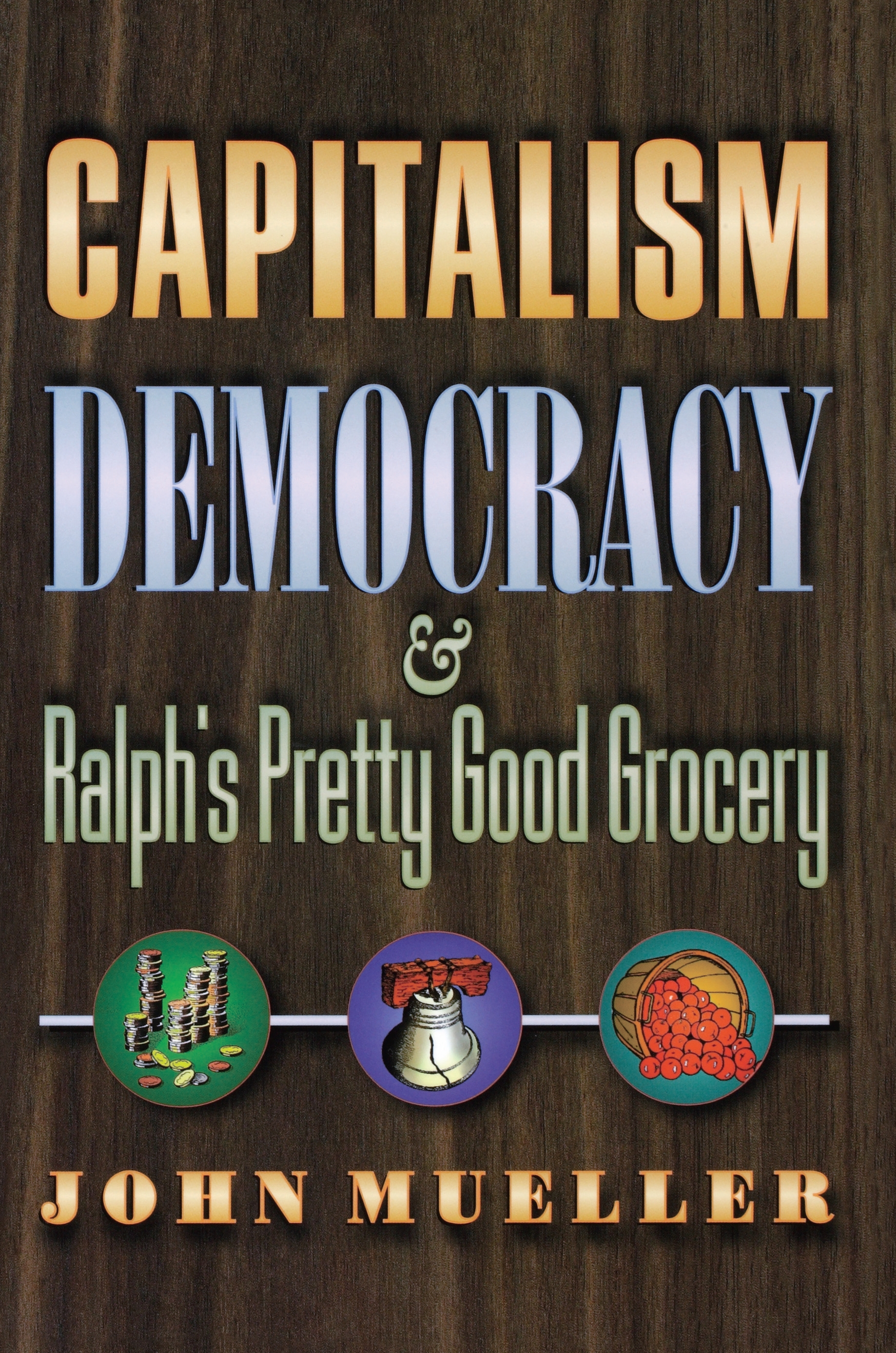
Capitalism, Democracy, and Ralph's Pretty Good Grocery Democracy is overrated. Capitalism, on the other hand, doesn't get enough credit. In this provocative and engaging book, John Mueller argues that these mismatches between image and reality create significant political and economic problems--inspiring instability, inefficiency, and widespread cynicism. We would be far better off, he writes, if we recognized that neither system is ideal or disastrous and accepted instead the humdrum truth that both are "pretty good." And, to Mueller, that means good enough. He declares that what is true of Garrison Keillor's fictional store "Ralph's Pretty Good Grocery" is also true of democracy and capitalism: if you can't get what you want there, "you can probably get along without it." Mueller begins by noting that capitalism is commonly thought to celebrate greed and to require discourtesy, deceit, and callousness. However, with examples that range from car dealerships and corporate boardrooms to the shop of an eighteenth-century silk merchant, Mueller shows that capitalism in fact tends to reward behavior that is honest, fair, civil, and compassionate. He argues that this gap between image and reality hampers economic development by encouraging people to behave dishonestly, unfairly, and discourteously to try to get ahead and to neglect the virtuous behavior that is an important source of efficiency and gain. The problem with democracy's image, by contrast, is that our expectations are too high. We are too often led by theorists, reformers, and romantics to believe that democracy should consist of egalitarianism and avid civic participation. In fact, democracy will always be chaotic, unequal, and marked by apathy. It offers reasonable freedom and security, but not political paradise. To idealize democracy, Mueller writes, is to undermine it, since the inevitable contrast with reality creates public cynicism and can hamper democracy's growth and development. Mueller presents these arguments with sophistication, wit, and erudition. He combines mastery of current political and economic literature with references to figures ranging from Plato to P. T. Barnum, from Immanuel Kant to Ronald Reagan, from Shakespeare to Frank Capra. Broad in scope and rich in detail, the book will provoke debate among economists, political scientists, and anyone interested in the problems (or non-problems) of modern democracy and capitalism. POLITICAL SCIENCE,Political Ideologies,Democracy
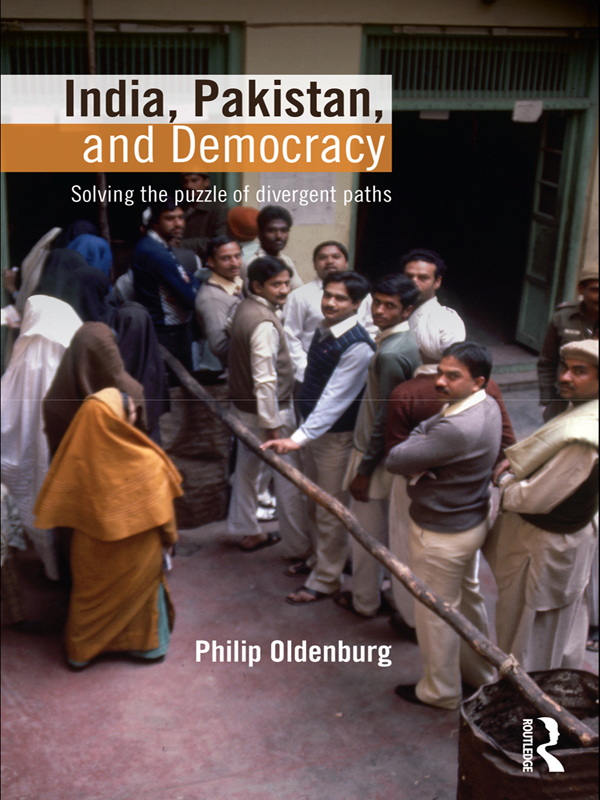
India, Pakistan, and Democracy The question of why some countries have democratic regimes and others do not is a significant issue in comparative politics. This book looks at India and Pakistan, two countries with clearly contrasting political regime histories, and presents an argument on why India is a democracy and Pakistan is not. Focusing on the specificities and the nuances of each state system, the author examines in detail the balance of authority and power between popular or elected politicians and the state apparatus through substantial historical analysis. India and Pakistan are both large, multi-religious and multi-lingual countries sharing a geographic and historical space that in 1947, when they became independent from British rule, gave them a virtually indistinguishable level of both extreme poverty and inequality. All of those factors militate against democracy, according to most theories, and in Pakistan democracy did indeed fail very quickly after Independence. It has only been restored as a façade for military-bureaucratic rule for brief periods since then. In comparison, after almost thirty years of democracy, India had a brush with authoritarian rule, in the 1975-76 Emergency, and some analysts were perversely reassured that the India exception had been erased. But instead, after a momentous election in 1977, democracy has become stronger over the last thirty years. Providing a comparative analysis of the political systems of India and Pakistan as well as a historical overview of the two countries, this textbook constitutes essential reading for students of South Asian History and Politics. It is a useful and balanced introduction to the politics of India and Pakistan. POLITICAL SCIENCE,Political Ideologies,Democracy
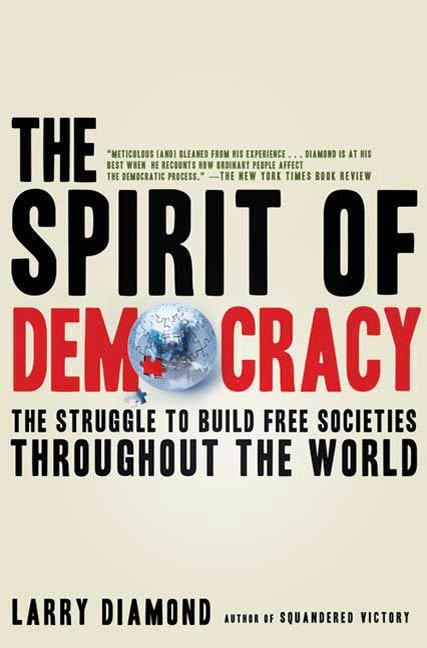
The Spirit of Democracy One of America's preeminent experts on democracy charts the future prospects for freedom around the world in the aftermath of Iraq and deepening authoritarianism Over three decades, the world was transformed. In 1974, nearly three-quarters of all countries were dictatorships; today, more than half are democracies. Yet recent efforts to promote democracy have stumbled, and many democratic governments are faltering. In this bold and sweeping vision for advancing freedom around the world, social scientist Larry Diamond examines how and why democracy progresses. He demonstrates that the desire for democracy runs deep, even in very poor countries, and that seemingly entrenched regimes like Iran and China could become democracies within a generation. He also dissects the causes of the "democratic recession" in critical states, including the crime-infested oligarchy in Russia and the strong-armed populism of Venezuela. Diamond cautions that arrogance and inconsistency have undermined America's aspirations to promote democracy. To spur a renewed democratic boom, he urges vigorous support of good governance—the rule of law, security, protection of individual rights, and shared economic prosperity—and free civic organizations. Only then will the spirit of democracy be secured. POLITICAL SCIENCE,Political Ideologies,Democracy
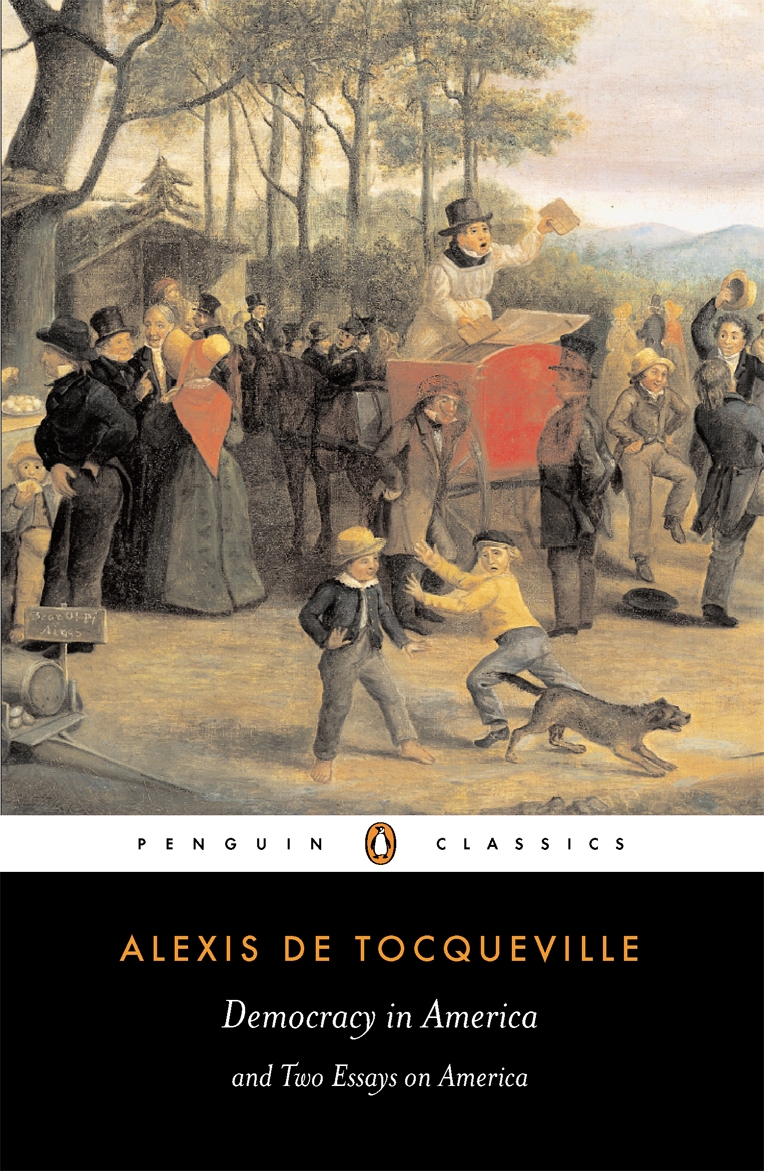
Democracy in America One of the most influential political texts ever written on America, and an indispensable authority on the nature of democracy In 1831 Alexis de Tocqueville, a young French aristocrat and civil servant, made a nine-month journey through eastern America. The result was Democracy in America, a monumental study of the strengths and weaknesses of the nation's evolving politics. Tocqueville looked to the flourishing democratic system in America as a possible model for post-revolutionary France, believing its egalitarian ideals reflected the spirit of the age. This edition, the only one that contains all Tocqueville's writings on America, includes the rarely translated 'Two Weeks in the Wilderness', an evocative account of Tocqueville's travels among the Iroquois and Chippeway, and 'Excursion to Lake Oneida'. Translated by Gerald Bevan with an Introduction and Notes by Isaac Kramnick POLITICAL SCIENCE,Political Ideologies,Democracy

The Federalist Papers A selection of nineteen essential essays from The Federalist Papers in their original lengths by James Madison, Alexander Hamilton and John Jay, with notes by Richard Beeman Penguin presents a series of six portable, accessible, and—above all—essential reads from American political history, selected by leading scholars. Series editor Richard Beeman, author of The Penguin Guide to the U.S. Constitution, draws together the great texts of American civic life to create a timely and informative mini-library of perennially vital issues. Whether readers are encountering these classic writings for the first time, or brushing up in anticipation of the 50th anniversary of the Civil Rights Act, these slim volumes will serve as a powerful and illuminating resource for scholars, students, and civic-minded citizens.Written at a time when furious arguments were raging about the best way to govern America, The Federalist Papers had the immediate practical aim of persuading New Yorkers to accept the newly drafted Constitution in 1787. In this they were supremely successful, but their influence also transcended contemporary debate to win them a lasting place in discussions of American political theory. The Federalist Papers make a powerful case for power-sharing between State and Federal authorities and have only risen in legal influence over the last two centuries. Beeman’s analysis helps clarify the goals, at once separate and in concert, of Madison, Hamilton, and Jay during their writing, and his selection of some of the most important papers show the array of issues—both philosophical and policy-specific—covered by this body of work. "The best commentary on the principles of government which ever was written" - Thomas Jefferson POLITICAL SCIENCE,Political Ideologies,Democracy
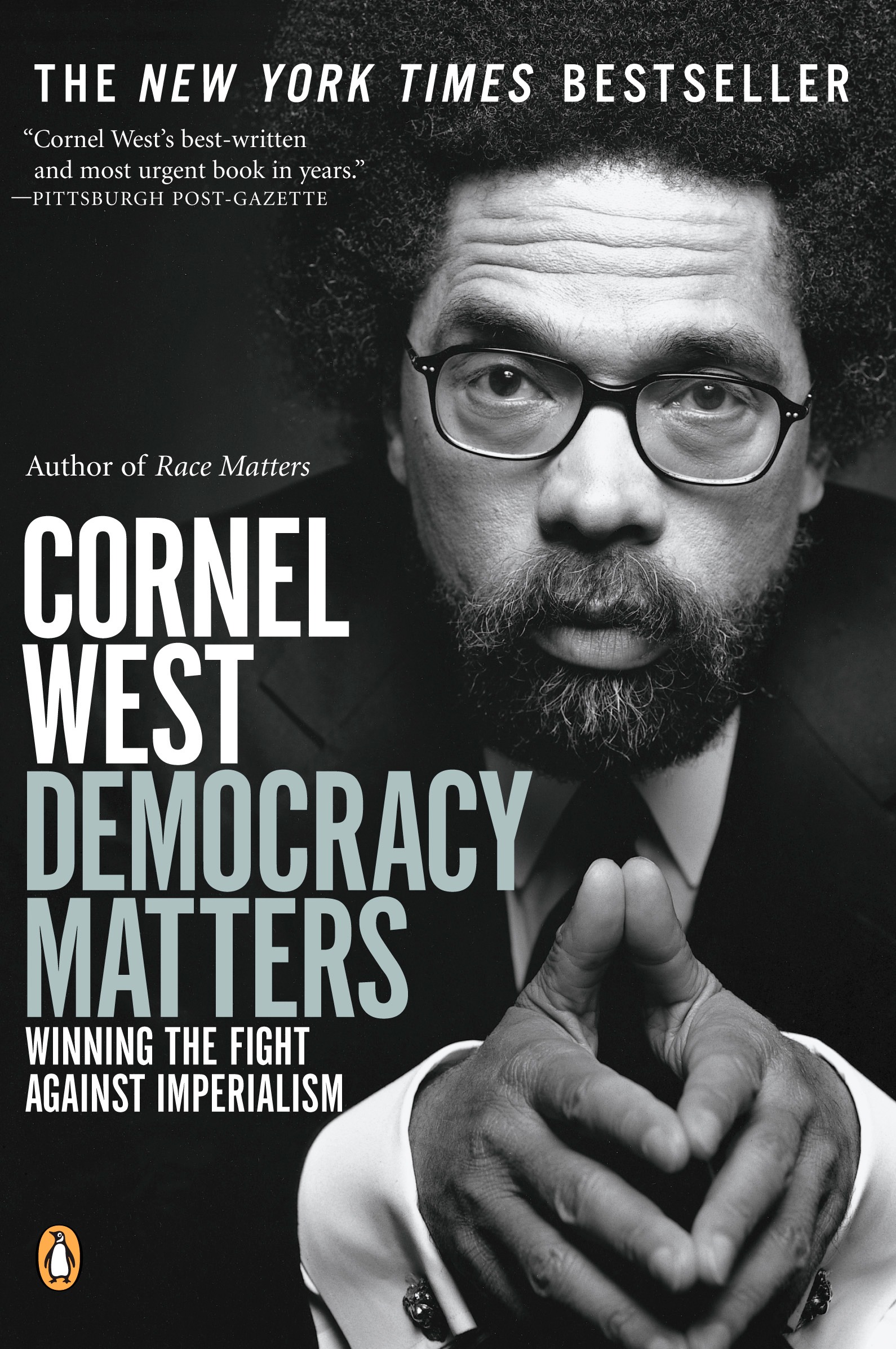
Democracy Matters In his major bestseller, Race Matters, philosopher Cornel West burst onto the national scene with his searing analysis of the scars of racism in American democracy. Race Matters has become a contemporary classic, still in print after ten years, having sold more than four hundred thousand copies. A mesmerizing speaker with a host of fervidly devoted fans, West gives as many as one hundred public lectures a year and appears regularly on radio and television. Praised by The New York Times for his "ferocious moral vision" and hailed by Newsweek as "an elegant prophet with attitude," he bridges the gap between black and white opinion about the country's problems.In Democracy Matters, West returns to the analysis of the arrested development of democracy-both in America and in the crisis-ridden Middle East. In a strikingly original diagnosis, he argues that if America is to become a better steward of democratization around the world, we must first wake up to the long history of imperialist corruption that has plagued our own democracy. Both our failure to foster peace in the Israeli-Palestinian conflict and the crisis of Islamist anti-Americanism stem largely from hypocrisies in our dealings with the world. Racism and imperial expansionism have gone hand in hand in our country's inexorable drive toward hegemony, and our current militarism is only the latest expression of that drive. Even as we are shocked by Islamic fundamentalism, our own brand of fundamentalism, which West dubs Constantinian Christianity, has joined forces with imperialist corporate and political elites in an unholy alliance, and four decades after the murder of Dr. Martin Luther King, Jr., insidious racism still inflicts debilitating psychic pain on so many of our citizens. But there is a deep democratic tradition in America of impassioned commitment to the fight against imperialist corruptions-the last great expression of which was the civil rights movement led by Dr. King-and West brings forth the powerful voices of that great democratizing tradition in a brilliant and deeply moving call for the revival of our better democratic nature. His impassioned and provocative argument for the revitalization of America's democracy will reshape the terms of the raging national debate about America's role in today's troubled world. POLITICAL SCIENCE,Political Ideologies,Democracy
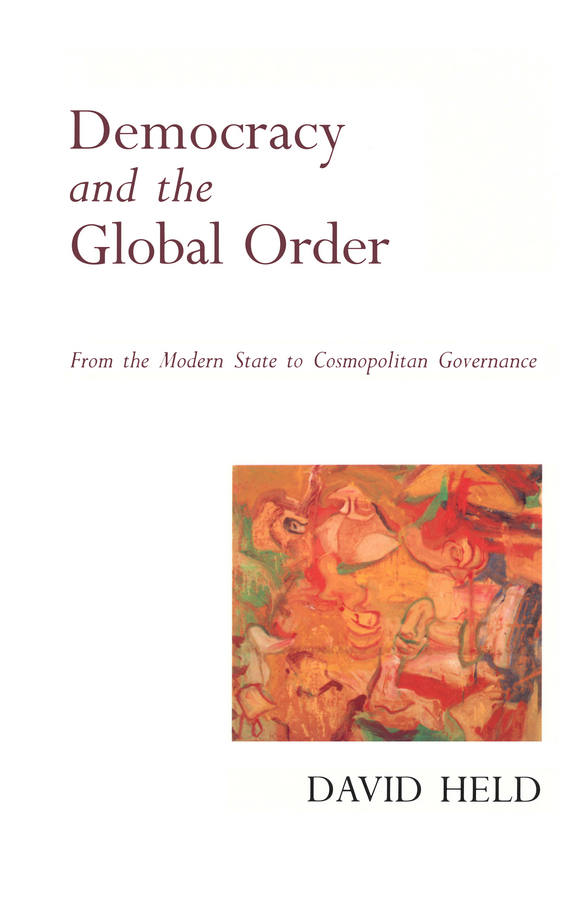
Democracy and the Global Order This book provides a highly original account of the changing meaning of democracy in the contemporary world, offering both an historical and philosophical analysis of the nature and prospects of democracy today. POLITICAL SCIENCE,Political Ideologies,Democracy
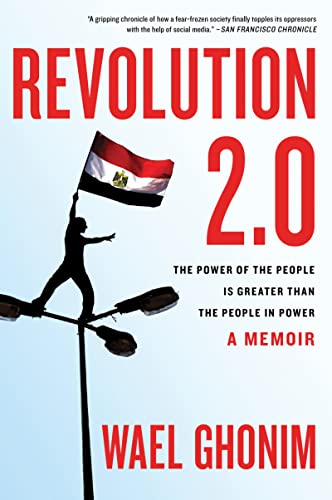
Revolution 2.0 A narrative of the revolution in Egypt, followed by lessons that can be applied to any revolution, anywhere. POLITICAL SCIENCE,Political Ideologies,Democracy
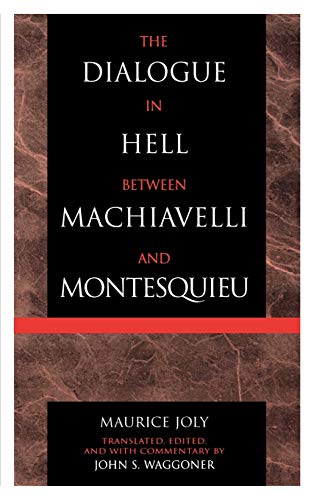
The Dialogue in Hell between Machiavelli and Montesquieu John Waggoner's superb translation of and commentary on Joly's Dialogue—the first faithful translation in English—seeks not only to update the sordid legacy of the The Protocols of the Elders of Zion but to redeem Joly's original work for serious study in its own right, rather than through the lens of antisemitism. Waggoner's work vindicates a man who was neither an antisemite nor a supporter of the kind of tyrannical politics the Protocols subsequently served, and presents Maurice Joly, once much maligned and too long ignored, as one of the nineteenth century's foremost political thinkers. POLITICAL SCIENCE,Political Ideologies,Democracy

Alexis de Tocqueville Considered one of the most influential works of the 19th century, Democracy in America offers insights into American politics that still ring true today Alexis de Tocqueville, a young aristocratic French lawyer, came to the United States in 1831 to study its penitentiary systems. His nine-month visit and subsequent reading and reflection resulted in Democracy in America (1835–40), a landmark masterpiece of political observation and analysis. Tocqueville vividly describes the unprecedented social equality he found in America and explores its implications for European society in the emerging modern era. His book provides enduring insight into the political consequences of widespread property ownership, the potential dangers to liberty inherent in majority rule, the vital role of religion in American life, and the importance of civil institutions in an individualistic culture dominated by the pursuit of material self-interest. He also probes the deep differences between the free and slave states, writing prophetically of racism, bigotry, and prejudice in the United States. Brought to life by Arthur Goldhammer's clear, fluid, and vigorous translation, this volume of Democracy in America is the first to fully capture Tocqueville’s achievements both as an accomplished literary stylist and as a profound political thinker. LIBRARY OF AMERICA is an independent nonprofit cultural organization founded in 1979 to preserve our nation’s literary heritage by publishing, and keeping permanently in print, America’s best and most significant writing. The Library of America series includes more than 300 volumes to date, authoritative editions that average 1,000 pages in length, feature cloth covers, sewn bindings, and ribbon markers, and are printed on premium acid-free paper that will last for centuries. POLITICAL SCIENCE,Political Ideologies,Democracy

The Art of Democracy "Cullen's strength comes from his understanding of how the different strands of American society intertwine in imaginative, unpredictable ways ... The shape and vitality of pop culture's next era will depend, at least in part, on commentators like Cullen." Washington Post Book World "A thoroughly engaging look at American culture ... Cullen's articulate prose is spiced with wicked wit and he loves a good story ... Demonstrates a sophisticated understanding of complex cultural forces." Publishers Weekly "Reflecting both the strengths and weaknesses of an unusually dynamic area of historical scholarship, The Art of Democracy is one of the best surveys of the history of American popular culture." Journal of American History "An exceptionally well-written and engrossing introduction to the nonelitist art forms of American popular culture ... Highly recommended." Library Journal, starred review "Should be kept on hand to restore our faith in the things that matter to us." American Studies Popular culture has been a powerful force in the United States, resonating within the society as a whole and at the same time connecting disparate and even hostile constituencies. The novels of the late 18th and early 19th centuries, the theater and minstrel shows of the mid-19th century, movies and the introduction of television and computers in the 20th century are the building blocks that Jim Cullen uses to show how unique and vibrant cultural forms overcame initial resistance and enabled historically marginalized groups to gain access to the fruits of society and recognition from the mainstream. This updated edition contains a new preface and final chapter which traces the history of contemporary computing from its World War II origins as a military tool to its widespread use in the late 20th century as a tool for the masses. Cullen shows how the computer is reshaping popular culture, and how that culture retains its capacity to surprise and disturb. The highly acclaimed first edition of The Art of Democracy won the 1996 Ray and Pat Brown Award for "Best Book," presented by the Popular Culture Association. POLITICAL SCIENCE,Political Ideologies,Democracy

Beasts and Gods An extraordinary historical, political and philosophical work that is set to not only reconfigure our understanding of democracy, but to challenge the individualistic basis of the modern liberal politics. POLITICAL SCIENCE,Political Ideologies,Democracy
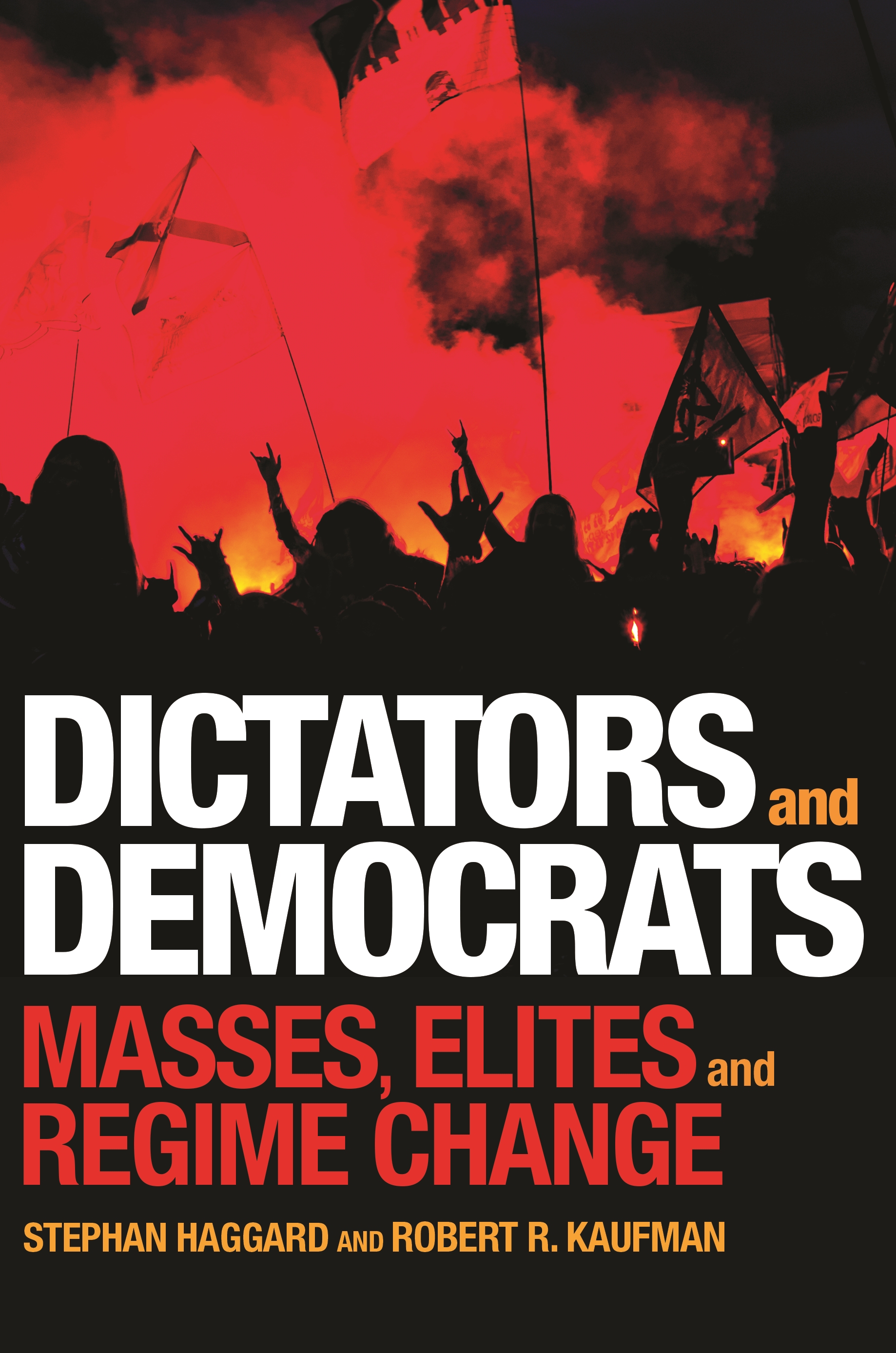
Dictators and Democrats A rigorous and comprehensive account of recent democratic transitions around the world From the 1980s through the first decade of the twenty-first century, the spread of democracy across the developing and post-Communist worlds transformed the global political landscape. What drove these changes and what determined whether the emerging democracies would stabilize or revert to authoritarian rule? Dictators and Democrats takes a comprehensive look at the transitions to and from democracy in recent decades. Deploying both statistical and qualitative analysis, Stephen Haggard and Robert Kaufman engage with theories of democratic change and advocate approaches that emphasize political and institutional factors. While inequality has been a prominent explanation for democratic transitions, the authors argue that its role has been limited, and elites as well as masses can drive regime change. Examining seventy-eight cases of democratic transition and twenty-five reversions since 1980, Haggard and Kaufman show how differences in authoritarian regimes and organizational capabilities shape popular protest and elite initiatives in transitions to democracy, and how institutional weaknesses cause some democracies to fail. The determinants of democracy lie in the strength of existing institutions and the public's capacity to engage in collective action. There are multiple routes to democracy, but those growing out of mass mobilization may provide more checks on incumbents than those emerging from intra-elite bargains. Moving beyond well-known beliefs regarding regime changes, Dictators and Democrats explores the conditions under which transitions to democracy are likely to arise. POLITICAL SCIENCE,Political Ideologies,Democracy

Models of Democracy The first two editions of Models of Democracy have proven immensely popular among students and specialists worldwide. In a succinct and far-reaching analysis, David Held provides an introduction to central accounts of democracy from classical Greece to the present and a critical discussion of what democracy should mean today. This new edition has been extensively revised and updated to take account of significant transformations in world politics, and a new chapter has been added on deliberative democracy which focuses not only on how citizen participation can be increased in politics, but also on how that participation can become more informed. Like its predecessor, the third edition of Models of Democracy combines lucid exposition and clarity of expression with careful scholarship and originality, making it highly attractive to students and experts in the field. The third edition will prove essential reading for all those interested in politics, political theory and political philosophy. A companion website to Models of Democracy provides lecturer and student resources; including a study guide, an interview with the author and links to develop the reader's understanding of the topics covered. POLITICAL SCIENCE,Political Ideologies,Democracy

Democracy From the former secretary of state and bestselling author -- a sweeping look at the global struggle for democracy and why America must continue to support the cause of human freedom. "This heartfelt and at times very moving book shows why democracy proponents are so committed to their work...Both supporters and skeptics of democracy promotion will come away from this book wiser and better informed." -- The New York Times From the end of the Cold War and the collapse of the Soviet Union to the ongoing struggle for human rights in the Middle East, Condoleezza Rice has served on the front lines of history. As a child, she was an eyewitness to a third awakening of freedom, when her hometown of Birmingham, Alabama, became the epicenter of the civil rights movement for black Americans. In this book, Rice explains what these epochal events teach us about democracy. At a time when people around the world are wondering whether democracy is in decline, Rice shares insights from her experiences as a policymaker, scholar, and citizen, in order to put democracy's challenges into perspective. When the United States was founded, it was the only attempt at self-government in the world. Today more than half of all countries qualify as democracies, and in the long run that number will continue to grow. Yet nothing worthwhile ever comes easily. Using America's long struggle as a template, Rice draws lessons for democracy around the world -- from Russia, Poland, and Ukraine, to Kenya, Colombia, and the Middle East. She finds that no transitions to democracy are the same because every country starts in a different place. Pathways diverge and sometimes circle backward. Time frames for success vary dramatically, and countries often suffer false starts before getting it right. But, Rice argues, that does not mean they should not try. While the ideal conditions for democracy are well known in academia, they never exist in the real world. The question is not how to create perfect circumstances but how to move forward under difficult ones. These same insights apply in overcoming the challenges faced by governments today. The pursuit of democracy is a continuing struggle shared by people around the world, whether they are opposing authoritarian regimes, establishing new democratic institutions, or reforming mature democracies to better live up to their ideals. The work of securing it is never finished. NEW YORK TIMES BESTSELLER POLITICAL SCIENCE,Political Ideologies,Democracy
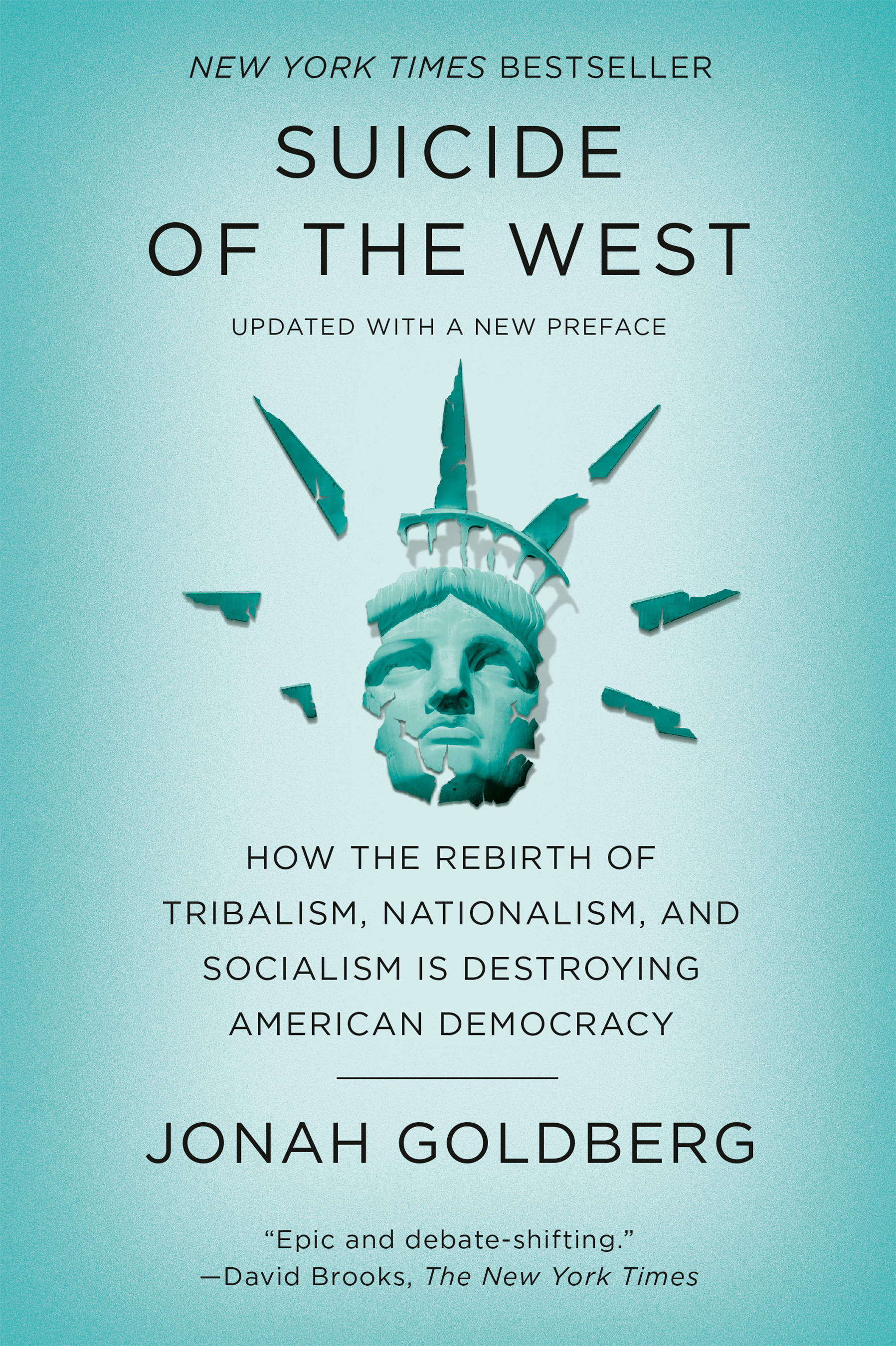
Suicide of the West NEW YORK TIMES BESTSELLER • An urgent argument that America and other democracies are in peril because they have lost the will to defend the values and institutions that sustain freedom and prosperity. “Epic and debate-shifting.”—David Brooks, New York Times Only once in the last 250,000 years have humans stumbled upon a way to lift ourselves out of the endless cycle of poverty, hunger, and war that defines most of history. If democracy, individualism, and the free market were humankind’s destiny, they should have appeared and taken hold a bit earlier in the evolutionary record. The emergence of freedom and prosperity was nothing short of a miracle. As Americans we are doubly blessed, because the radical ideas that made the miracle possible were written not just into the Constitution but in our hearts, laying the groundwork for our uniquely prosperous society. Those ideas are: • Our rights come from God, not from the government.
• The government belongs to us; we do not belong to it.
• The individual is sovereign. We are all captains of our own souls, not bound by the circumstances of our birth.
• The fruits of our labors belong to us.
In the last few decades, these political virtues have been turned into vices. As we are increasingly taught to view our traditions as a system of oppression, exploitation, and privilege, the principles of liberty and the rule of law are under attack from left and right. For the West to survive, we must renew our sense of gratitude for what our civilization has given us and rediscover the ideals and habits of the heart that led us out of the bloody muck of the past—or back to the muck we will go. POLITICAL SCIENCE,Political Ideologies,Democracy
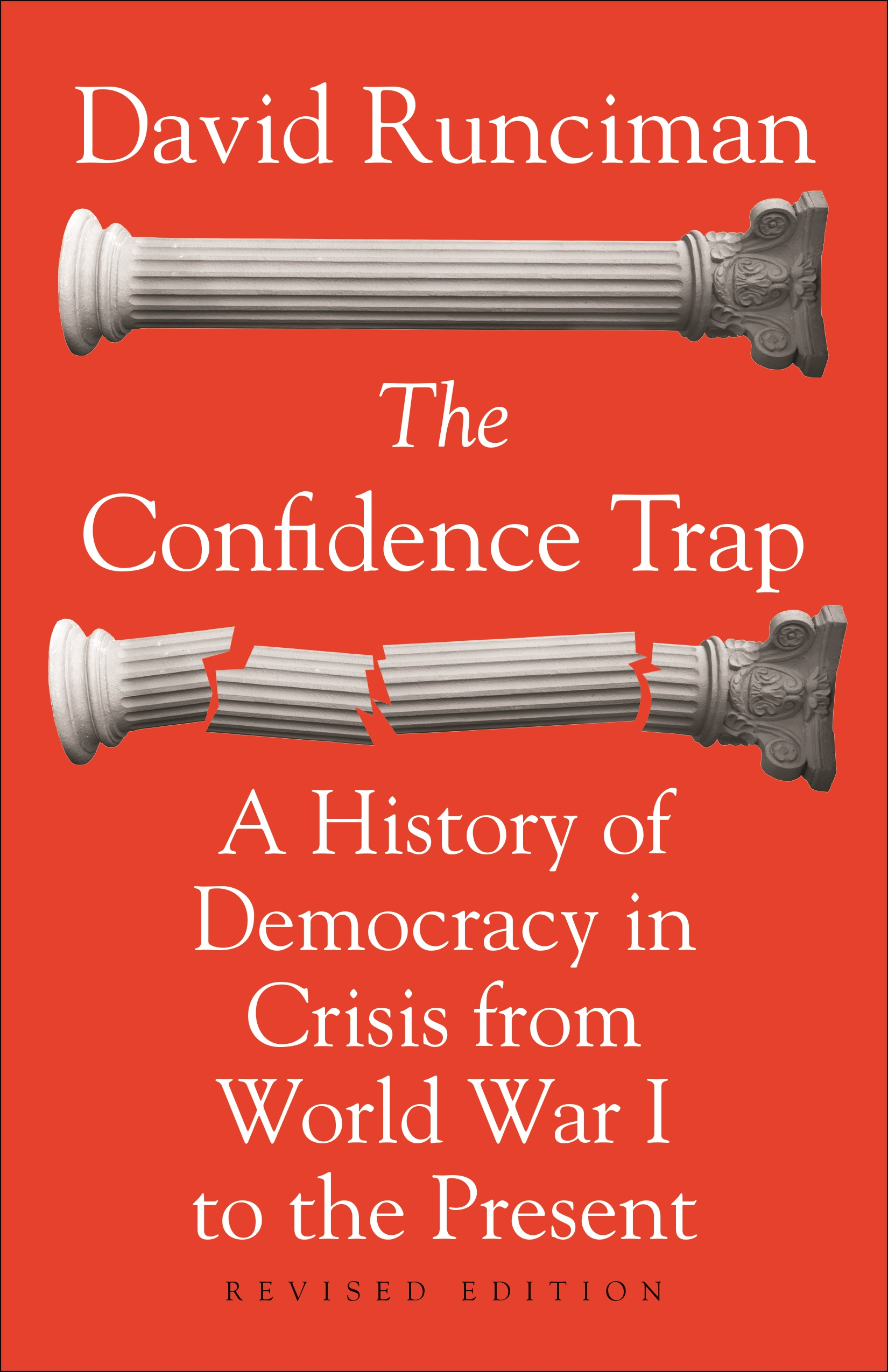
The Confidence Trap Why democracies believe they can survive any crisis—and why that belief is so dangerous Why do democracies keep lurching from success to failure? The current financial crisis is just the latest example of how things continue to go wrong, just when it looked like they were going right. In this wide-ranging, original, and compelling book, David Runciman tells the story of modern democracy through the history of moments of crisis, from the First World War to the economic crash of 2008. A global history with a special focus on the United States, The Confidence Trap examines how democracy survived threats ranging from the Great Depression to the Cuban missile crisis, and from Watergate to the collapse of Lehman Brothers. It also looks at the confusion and uncertainty created by unexpected victories, from the defeat of German autocracy in 1918 to the defeat of communism in 1989. Throughout, the book pays close attention to the politicians and thinkers who grappled with these crises: from Woodrow Wilson, Nehru, and Adenauer to Fukuyama and Obama. In The Confidence Trap, David Runciman shows that democracies are good at recovering from emergencies but bad at avoiding them. The lesson democracies tend to learn from their mistakes is that they can survive them—and that no crisis is as bad as it seems. Breeding complacency rather than wisdom, crises lead to the dangerous belief that democracies can muddle through anything—a confidence trap that may lead to a crisis that is just too big to escape, if it hasn't already. The most serious challenges confronting democracy today are debt, the war on terror, the rise of China, and climate change. If democracy is to survive them, it must figure out a way to break the confidence trap. POLITICAL SCIENCE,Political Ideologies,Democracy

How Democracy Ends How will democracy end? And what will replace it? A preeminent political scientist examines the past, present, and future of an endangered political philosophy Since the end of World War II, democracy's sweep across the globe seemed inexorable. Yet today, it seems radically imperiled, even in some of the world's most stable democracies. How bad could things get? In How Democracy Ends, David Runciman argues that we are trapped in outdated twentieth-century ideas of democratic failure. By fixating on coups and violence, we are focusing on the wrong threats. Our societies are too affluent, too elderly, and too networked to fall apart as they did in the past. We need new ways of thinking the unthinkable -- a twenty-first-century vision of the end of democracy, and whether its collapse might allow us to move forward to something better. A provocative book by a major political philosopher, How Democracy Ends asks the most trenchant questions that underlie the disturbing patterns of our contemporary political life. POLITICAL SCIENCE,Political Ideologies,Democracy
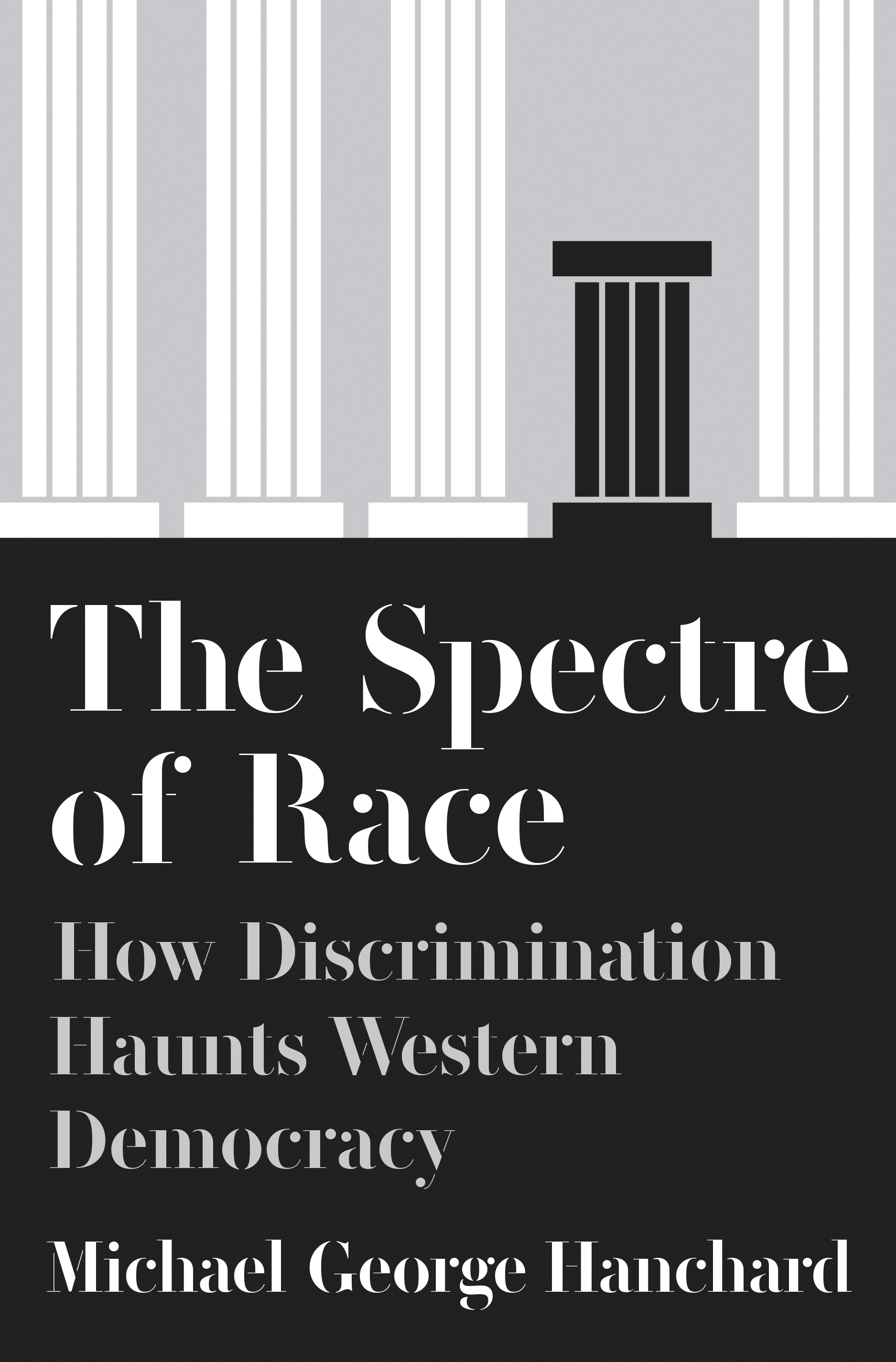
The Spectre of Race How racism and discrimination have been central to democracies from the classical period to today As right-wing nationalism and authoritarian populism gain momentum across the world, liberals, and even some conservatives, worry that democratic principles are under threat. In The Spectre of Race, Michael Hanchard argues that the current rise in xenophobia and racist rhetoric is nothing new and that exclusionary policies have always been central to democratic practices since their beginnings in classical times. Contending that democracy has never been for all people, Hanchard discusses how marginalization is reinforced in modern politics, and why these contradictions need to be fully examined if the dynamics of democracy are to be truly understood. Hanchard identifies continuities of discriminatory citizenship from classical Athens to the present and looks at how democratic institutions have promoted undemocratic ideas and practices. The longest-standing modern democracies--France, Britain, and the United States—profited from slave labor, empire, and colonialism, much like their Athenian predecessor. Hanchard follows these patterns through the Enlightenment and to the states and political thinkers of the late nineteenth and early twentieth centuries, and he examines how early political scientists, including Woodrow Wilson and his contemporaries, devised what Hanchard has characterized as "racial regimes" to maintain the political and economic privileges of dominant groups at the expense of subordinated ones. Exploring how democracies reconcile political inequality and equality, Hanchard debates the thorny question of the conditions under which democracies have created and maintained barriers to political membership. Showing the ways that race, gender, nationality, and other criteria have determined a person's status in political life, The Spectre ofRace offers important historical context for how democracy generates political difference and inequality. POLITICAL SCIENCE,Political Ideologies,Democracy
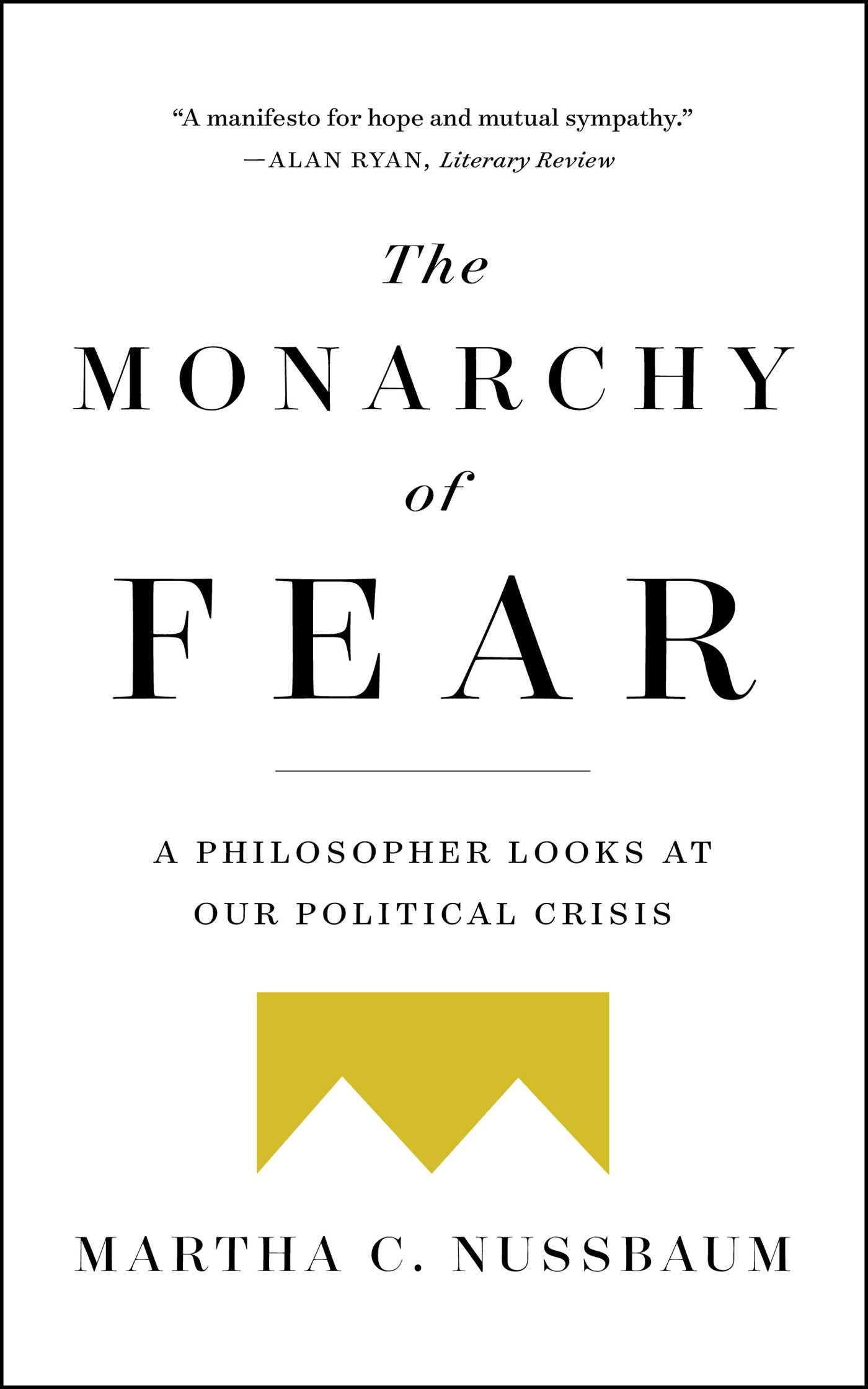
The Monarchy of Fear From one of the world’s most celebrated moral philosophers comes a thorough examination of the current political crisis and recommendations for how to mend our divided country. For decades Martha C. Nussbaum has been an acclaimed scholar and humanist, earning dozens of honors for her books and essays. In The Monarchy of Fear she turns her attention to the current political crisis that has polarized American since the 2016 election. Although today’s atmosphere is marked by partisanship, divisive rhetoric, and the inability of two halves of the country to communicate with one another, Nussbaum focuses on what so many pollsters and pundits have overlooked. She sees a simple truth at the heart of the problem: the political is always emotional. Globalization has produced feelings of powerlessness in millions of people in the West. That sense of powerlessness bubbles into resentment and blame. Blame of immigrants. Blame of Muslims. Blame of other races. Blame of cultural elites. While this politics of blame is exemplified by the election of Donald Trump and the vote for Brexit, Nussbaum argues it can be found on all sides of the political spectrum, left or right. Drawing on a mix of historical and contemporary examples, from classical Athens to the musical Hamilton, The Monarchy of Fear untangles this web of feelings and provides a roadmap of where to go next. POLITICAL SCIENCE,Political Ideologies,Democracy
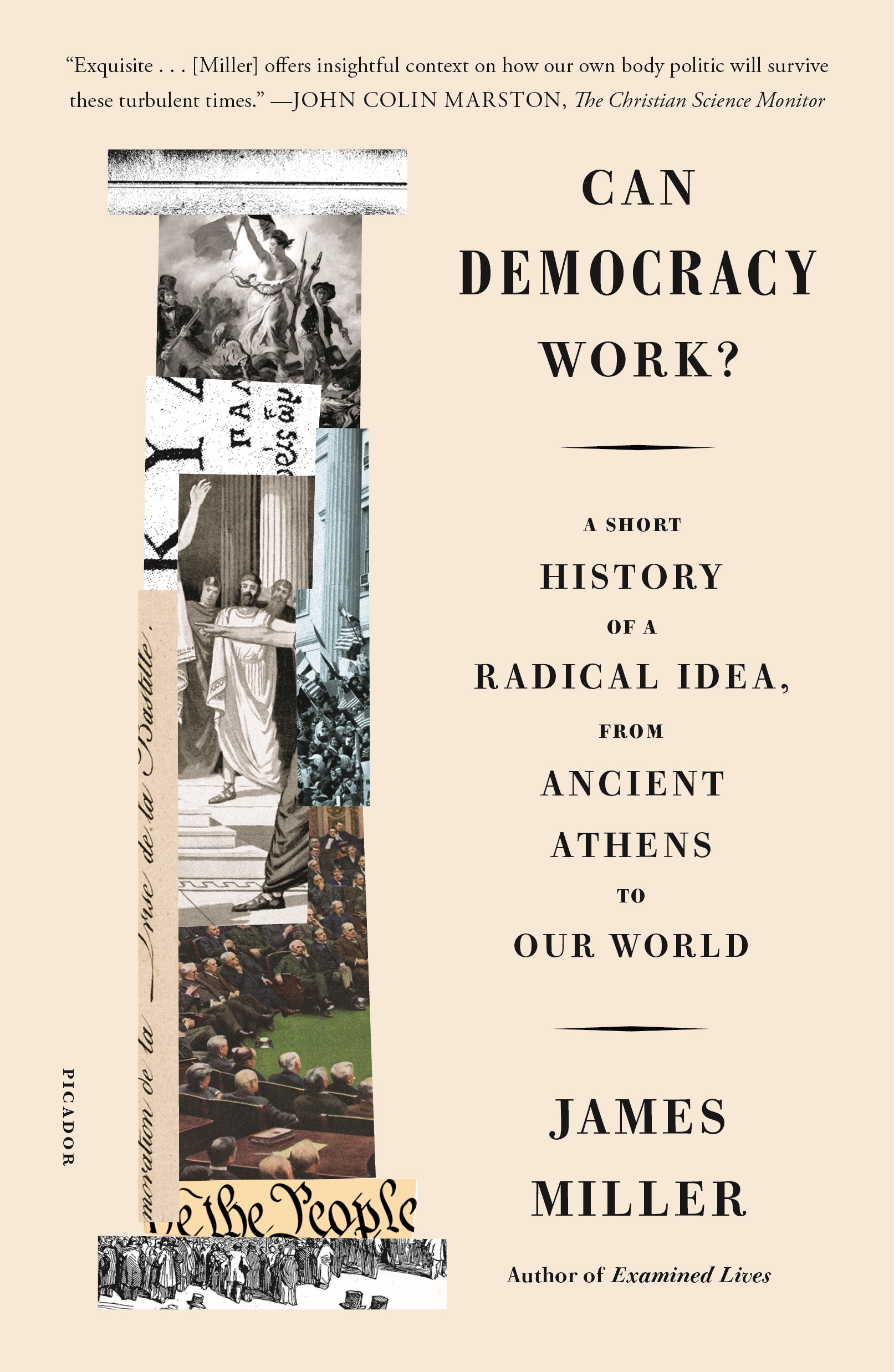
Can Democracy Work? A new history of the world’s most embattled idea Today, democracy is the world’s only broadly accepted political system, and yet it has become synonymous with disappointment and crisis. How did it come to this? In Can Democracy Work? James Miller, the author of the classic history of 1960s protest Democracy Is in the Streets, offers a lively, surprising, and urgent history of the democratic idea from its first stirrings to the present. As he shows, democracy has always been rife with inner tensions. The ancient Greeks preferred to choose leaders by lottery and regarded elections as inherently corrupt and undemocratic. The French revolutionaries sought to incarnate the popular will, but many of them came to see the people as the enemy. And in the United States, the franchise would be extended to some even as it was taken from others. Amid the wars and revolutions of the twentieth century, communists, liberals, and nationalists all sought to claim the ideals of democracy for themselves—even as they manifestly failed to realize them. Ranging from the theaters of Athens to the tents of Occupy Wall Street, Can Democracy Work? is an entertaining and insightful guide to our most cherished—and vexed—ideal. POLITICAL SCIENCE,Political Ideologies,Democracy

Democracy May Not Exist, but We'll Miss It When It's Gone What is democracy really? What do we mean when we use the term? And can it ever truly exist? Astra Taylor, hailed as a “New Civil Rights Leader†by the Los Angeles Times, provides surprising answers. There is no shortage of democracy, at least in name, and yet it is in crisis everywhere we look. From a cabal of plutocrats in the White House to gerrymandering and dark-money compaign contributions, it is clear that the principle of government by and for the people is not living up to its promise. The problems lie deeper than any one election cycle. As Astra Taylor demonstrates, real democracy—fully inclusive and completely egalitarian—has in fact never existed. In a tone that is both philosophical and anecdotal, weaving together history, theory, the stories of individuals, and interviews with such leading thinkers as Cornel West and Wendy Brown, Taylor invites us to reexamine the term. Is democracy a means or an end, a process or a set of desired outcomes? What if those outcomes, whatever they may be—peace, prosperity, equality, liberty, an engaged citizenry—can be achieved by non-democratic means? In what areas of life should democratic principles apply? If democracy means rule by the people, what does it mean to rule and who counts as the people? Democracy's inherent paradoxes often go unnamed and unrecognized. Exploring such questions, Democracy May Not Exist offers a better understanding of what is possible, what we want, why democracy is so hard to realize, and why it is worth striving for. POLITICAL SCIENCE,Political Ideologies,Democracy

National Populism A SUNDAY TIMES BOOK OF THE YEAR A crucial new guide to one of the most important and most dangerous phenomena of our time: the rise of populism in the West Across the West, there is a rising tide of people who feel excluded, alienated from mainstream politics, and increasingly hostile towards minorities, immigrants and neo-liberal economics. Many of these voters are turning to national populist movements, which pose the most serious threat to the Western liberal democratic system, and its values, since the Second World War. From the United States to France, Austria to the UK, the national populist challenge to mainstream politics is all around us. But what is behind this exclusionary turn? Who supports these movements and why? What does their rise tell us about the health of liberal democratic politics in the West? And what, if anything, should we do to respond to these challenges? Written by two of the foremost experts on fascism and the rise of the populist right, National Populism is a lucid and deeply-researched guide to the radical transformations of today's political landscape, revealing why liberal democracies across the West are being challenged-and what those who support them can do to help stem the tide. POLITICAL SCIENCE,Political Ideologies,Democracy
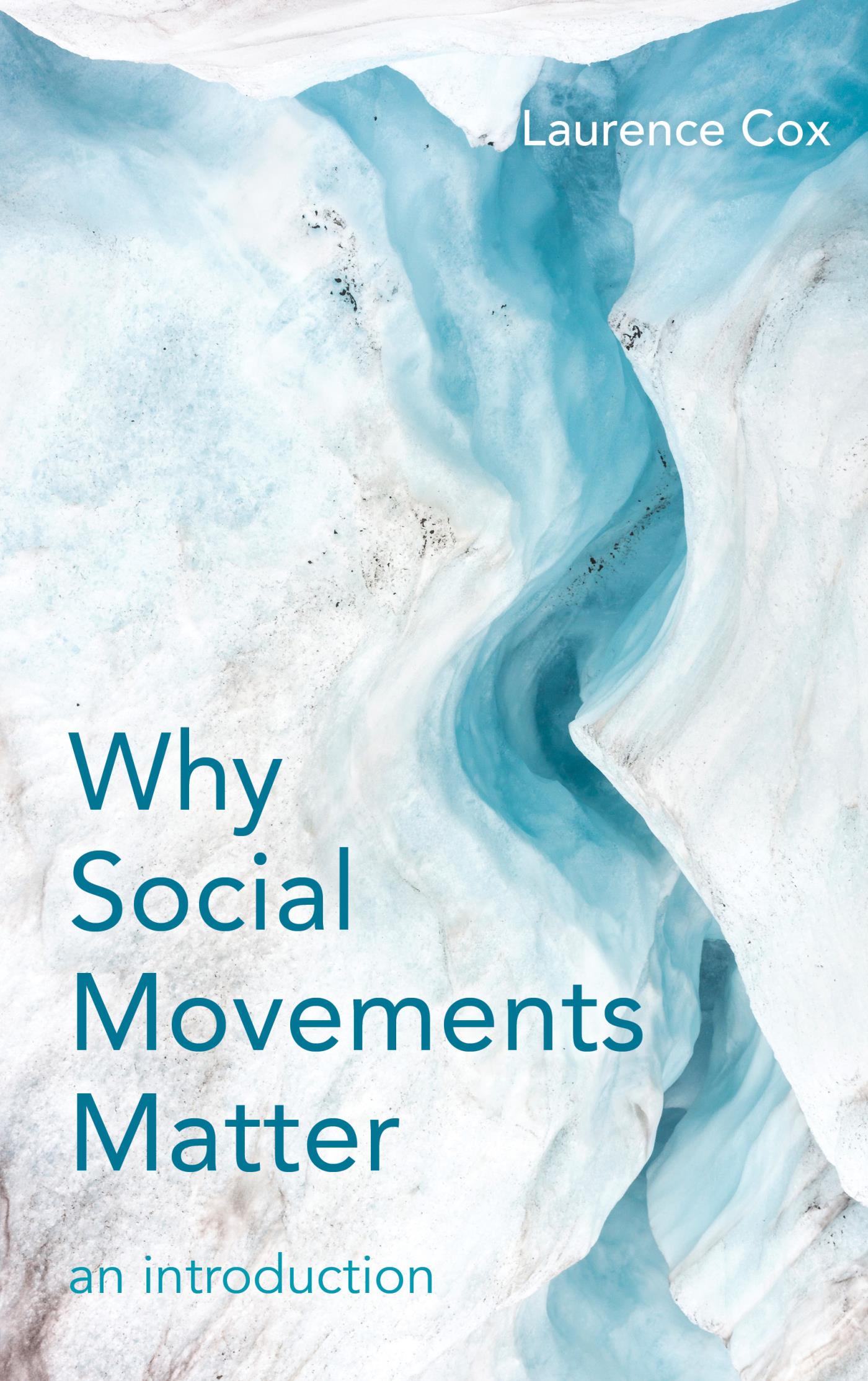
Why Social Movements Matter A short, clearly written, lively popularisation that requires no previous familiarity with movements or movement research. POLITICAL SCIENCE,Political Ideologies,Democracy
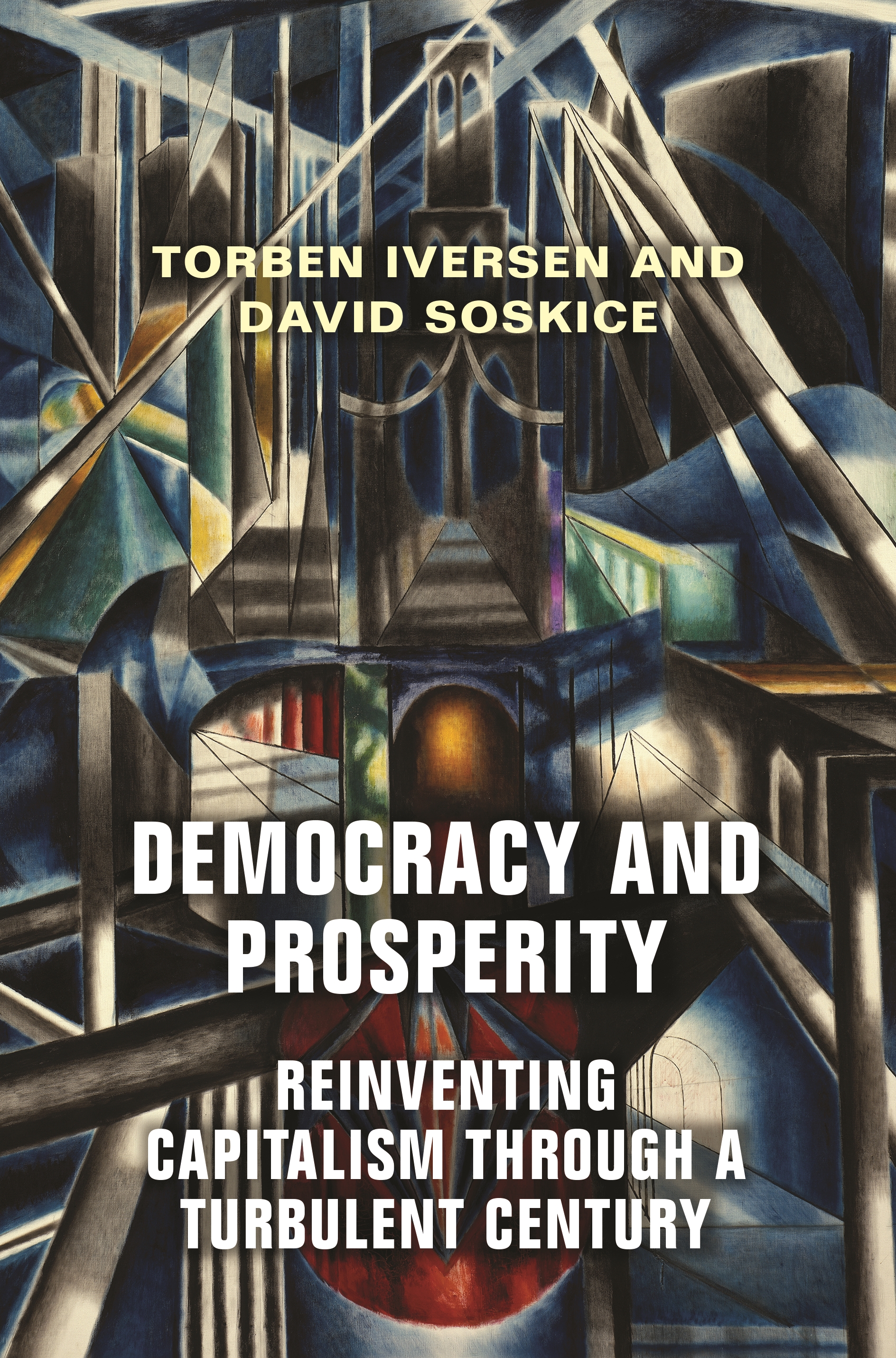
Democracy and Prosperity A groundbreaking new historical analysis of how global capitalism and advanced democracies mutually support each other It is a widespread view that democracy and the advanced nation-state are in crisis, weakened by globalization and undermined by global capitalism, in turn explaining rising inequality and mounting populism. This book, written by two of the world’s leading political economists, argues this view is wrong: advanced democracies are resilient, and their enduring historical relationship with capitalism has been mutually beneficial. For all the chaos and upheaval over the past century—major wars, economic crises, massive social change, and technological revolutions—Torben Iversen and David Soskice show how democratic states continuously reinvent their economies through massive public investment in research and education, by imposing competitive product markets and cooperation in the workplace, and by securing macroeconomic discipline as the preconditions for innovation and the promotion of the advanced sectors of the economy. Critically, this investment has generated vast numbers of well-paying jobs for the middle classes and their children, focusing the aims of aspirational families, and in turn providing electoral support for parties. Gains at the top have also been shared with the middle (though not the bottom) through a large welfare state. Contrary to the prevailing wisdom on globalization, advanced capitalism is neither footloose nor unconstrained: it thrives under democracy precisely because it cannot subvert it. Populism, inequality, and poverty are indeed great scourges of our time, but these are failures of democracy and must be solved by democracy. POLITICAL SCIENCE,Political Ideologies,Democracy
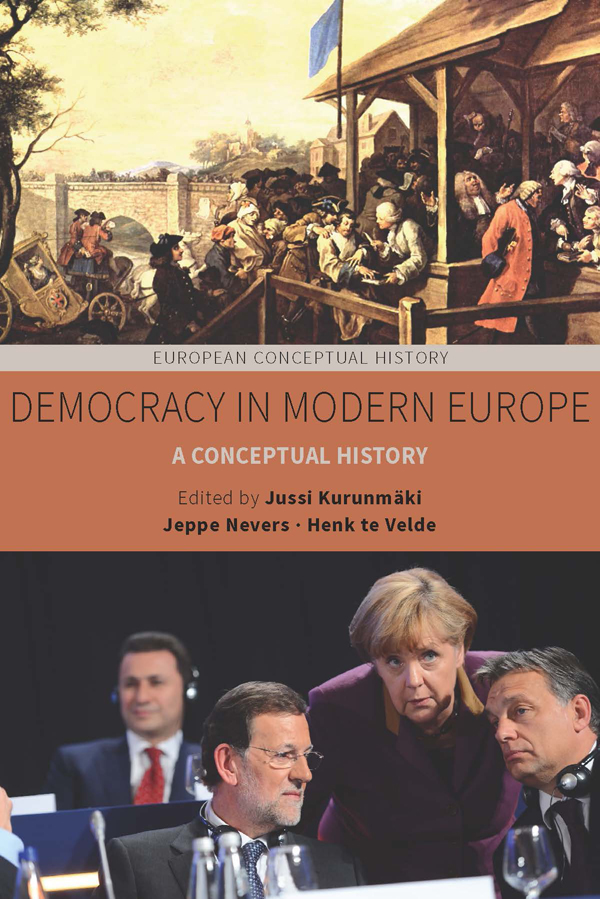
Democracy in Modern Europe As one of the most influential ideas in modern European history, democracy has fundamentally reshaped not only the landscape of governance, but also social and political thought throughout the world. Democracy in Modern Europe surveys the conceptual history of democracy in modern Europe, from the Industrial Revolutions of the nineteenth century through both world wars and the rise of welfare states to the present era of the European Union. Exploring individual countries as well as regional dynamics, this volume comprises a tightly organized, comprehensive, and thoroughly up-to-date exploration of a foundational issue in European political and intellectual history. POLITICAL SCIENCE,Political Ideologies,Democracy

Civil Society in the Age of Monitory Democracy Since the emergence of the dissident “parallel polis†in Eastern Europe, civil society has become a “new superpower,†influencing democratic transformations, human rights, and international co-operation; co-designing economic trends, security and defense; reshaping the information society; and generating new ideas on the environment, health, and the “good life.†This volume seeks to compare and reassess the role of civil society in the rich West, the poorer South, and the quickly expanding East in the context of the twenty-first century’s challenges. It presents a novel perspective on civic movements testing John Keane’s notion of “monitory democracyâ€: an emerging order of public scrutiny and monitoring of power. POLITICAL SCIENCE,Political Ideologies,Democracy
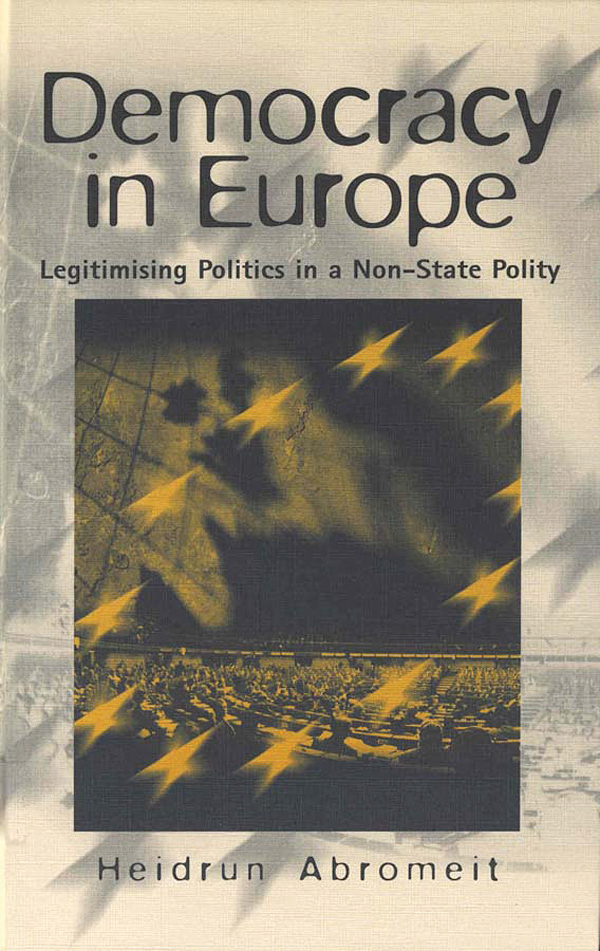
Democracy in Europe Since the beginning of the European Community students of international politics and of international, resp. Constitutional law, have been wondering what kind of animal it is, and will be, once integration has been completed. Whereas the EC Treaty of 1957 stressed the economic aspects and envisioned a steady and dynamic progress towards a Single Market, it was conspicuously silent about the political implications of integration and the new democratic order. What is needed, so the author argues in this powerful and original contribution to the debate on democratisation of the European Union, is a flexible system that supplements the European decision-making process with various direct democratic instruments such as the use of referenda. These would serve to increase the accountability of the politicians without demanding or requiring a definitive resolution of the exact constitutional status of the Union. POLITICAL SCIENCE,Political Ideologies,Democracy

Economy for and Against Democracy Political constitutions alone do not guarantee democracy; a degree of economic equality is also essential. Yet contemporary economies, dominated as they are by global finance and political rent-seekers, often block the realization of democracy. The comparative essays and case studies of this volume examine the contradictory relationship between the economy and democracy and highlight the struggles and visions needed to make things more equitable. They explore how our collective aspirations for greater democracy might be informed by serious empirical research on the human economy today. If we want a better world, we must act on existing social realities. POLITICAL SCIENCE,Political Ideologies,Democracy

Beyond Oligarchy A collection of essays by leading scholars of contemporary Indonesian politics and society, each addressing effects of material inequality on political power and contestation in democratic Indonesia. POLITICAL SCIENCE,Political Ideologies,Democracy
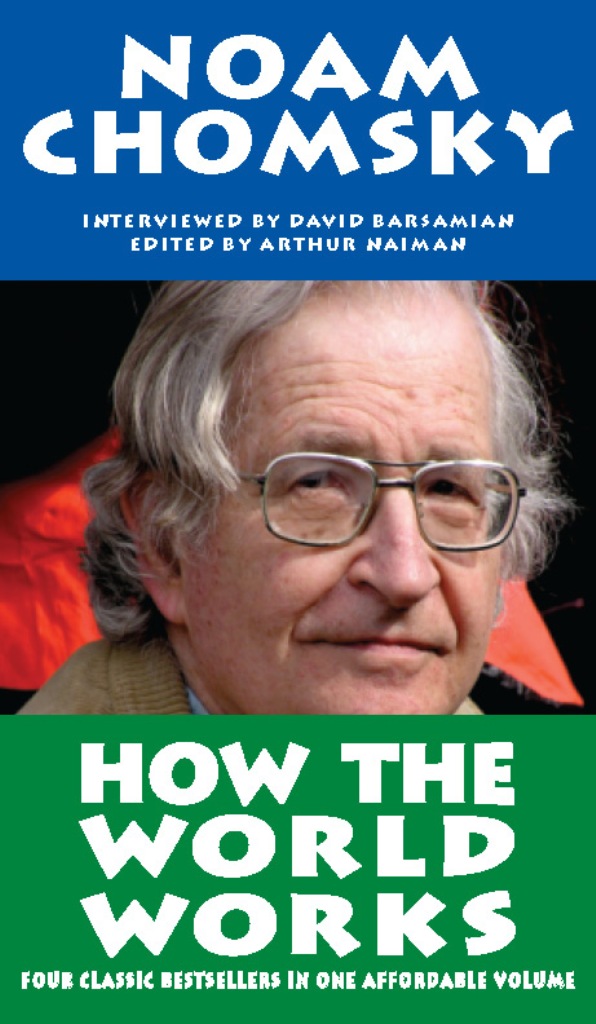
How the World Works According to The New York Times, Noam Chomsky is arguably the most important intellectual alive.†But he isn’t easy to read . . . or at least he wasn’t until these books came along. Made up of intensively edited speeches and interviews, they offer something not found anywhere else: pure Chomsky, with every dazzling idea and penetrating insight intact, delivered in clear, accessible, reader-friendly prose. Published as four short books in the famous Real Story seriesWhat Uncle Sam Really Wants; The Prosperous Few and the Restless Many; Secrets, Lies and Democracy; and The Common Goodthey’ve collectively sold almost 600,000 copies. And they continue to sell year after year after year because Chomsky’s ideas become, if anything, more relevant as time goes by. For example, twenty years ago he pointed out that in 1970, about 90% of international capital was used for trade and long-term investmentmore or less productive thingsand 10% for speculation. By 1990, those figures had reversed.†As we know, speculation continued to increase exponentially. We’re paying the price now for not heeding him them. POLITICAL SCIENCE,Political Ideologies,Democracy
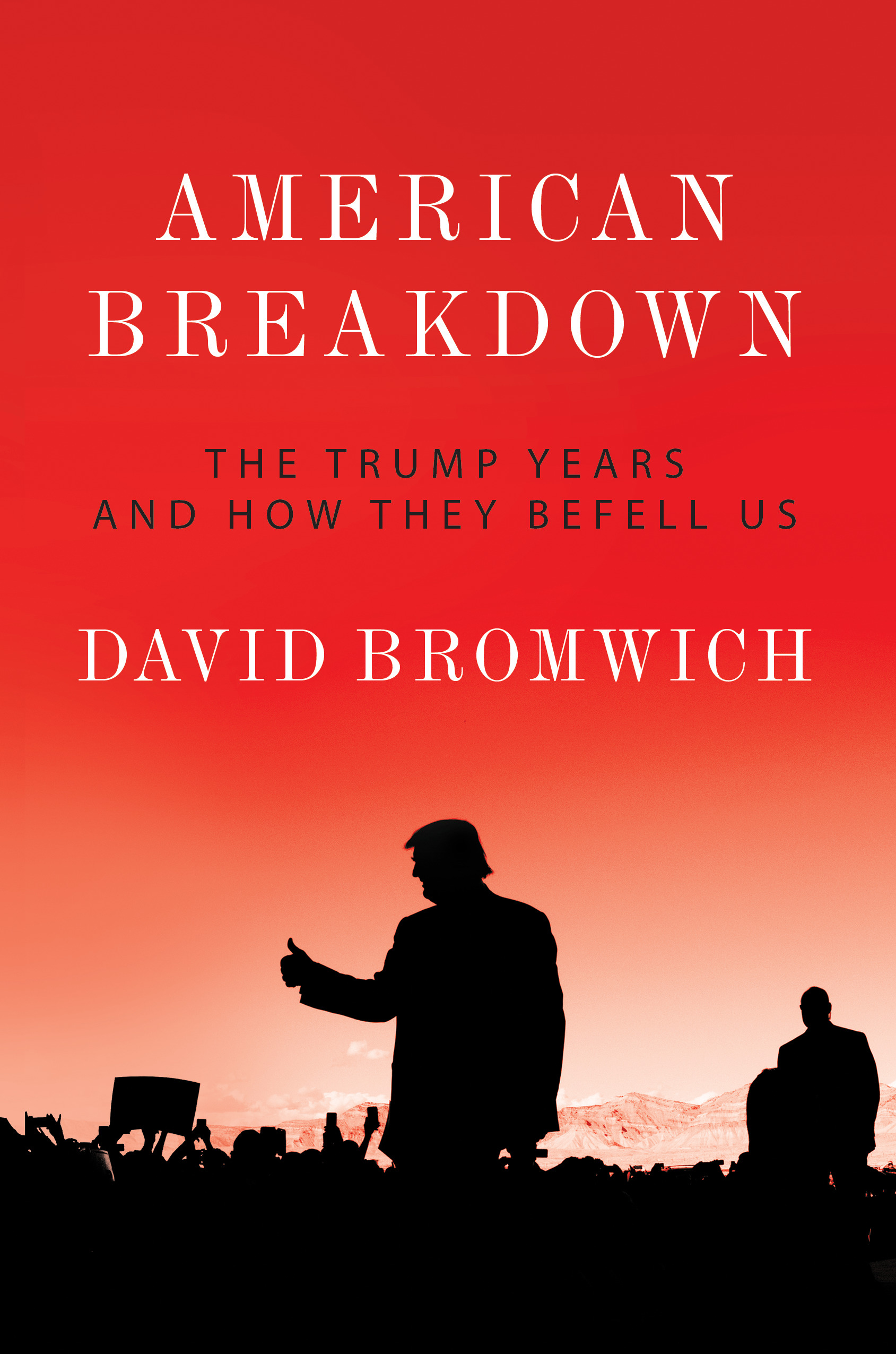
American Breakdown How Trump got to the Oval Office—and how both parties and the mainstream media are keeping him there Donald Trump’s residency in the White House is not an accident of American history, and it can’t be blamed on a single cause. In American Breakdown, David Bromwich provides an essential analysis of the forces in play beneath the surface of our political system. His portraits of political leaders and overarching narrative bring to life the events and machinations that have led America to a collective breakdown. The political conditions of the present crisis were put in place over fifty years ago, with the expansion of the Vietnam War and the lies and coverups that brought down Nixon. Since then, every presidency has further centralized and strengthened executive power. The truly catastrophic event in American life was the invention by George W. Bush and Dick Cheney of the War on Terror, designed to last for generations. Barack Obama’s practice of “reconciliation without truth”—sparing CIA torturers and Wall Street bankers—deepened the distrust and anger of an electorate that has rallied around Trump. An unsparing account of the degradation of US democracy, American Breakdown is essential to our evaluation of its prospects. Arguing that Trump’s re-election seems just as likely as impeachment, Bromwich turns his attention to the new struggles within the Democratic Party on immigration, foreign policy, and the Green New Deal. American Breakdown will be a crucial reference point in the political debate around the upcoming presidential election—a contest in which the forces that created Donald Trump show no sign of letting up. POLITICAL SCIENCE,Political Ideologies,Democracy

Hiding in Plain Sight Instant New York Times Bestseller Washington Post Bestseller USA Today BestsellerIndie Bound BestsellerAuthors Round the South BestsellerMidwest Indie Bestseller New York Times bestselling author Sarah Kendzior documents the truth about the calculated rise to power of Donald Trump since the 1980s and how the erosion of our liberties made an American demaÂgogue possible. The story of Donald Trump’s rise to power is the story of a buried American history – buried because people in power liked it that way. It was visible without being seen, influential without being named, ubiquitous without being overt. Sarah Kendzior’s Hiding in Plain Sight pulls back the veil on a history spanning decades, a history of an American autocrat in the making. In doing so, she reveals the inherent fragility of American democracy – how our continual loss of freedom, the rise of consolidated corruption, and the secrets behind a burgeoning autocratic United States have been hiding in plain sight for decades. In Kendzior’s signature and celebrated style, she expertly outlines Trump’s meteoric rise from the 1980s until today, interlinking key moments of his life with the degradation of the American political system and the continual erosion of our civil liberties by foreign powers. Kendzior also offers a never-before-seen look at her lifelong tendency to be in the wrong place at the wrong time – living in New York through 9/11 and in St. Louis during the Ferguson uprising, and researching media and authoritarianism when Trump emerged using the same tactics as the post-Soviet dictatorships she had long studied. It is a terrible feeling to sense a threat coming, but it is worse when we let apathy, doubt, and fear prevent us from preparing ourselves. Hiding in Plain Sight confronts the injustice we have too long ignored because the truth is the only way forward. POLITICAL SCIENCE,Political Ideologies,Democracy
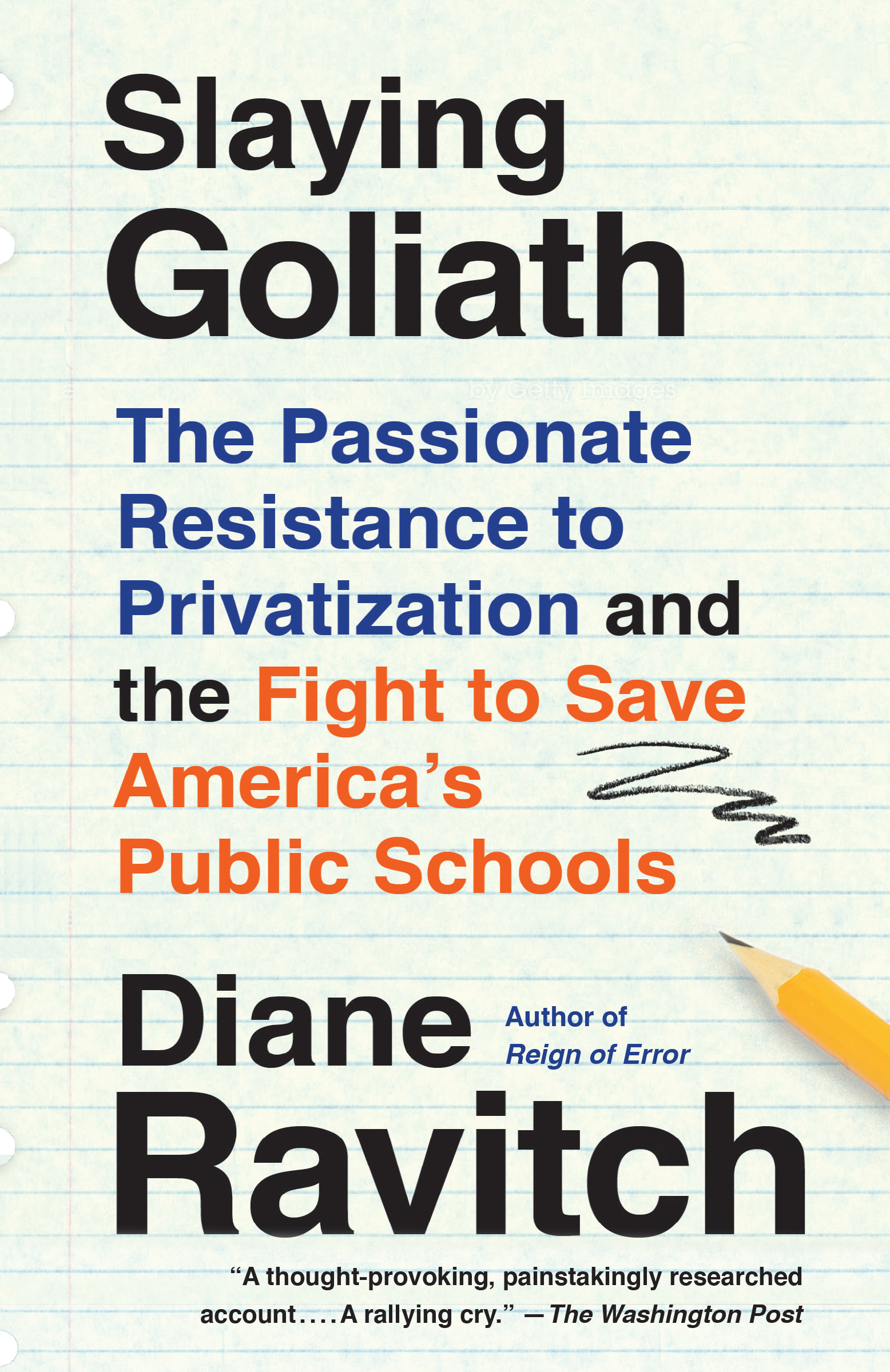
Slaying Goliath From one of the foremost authorities on education in the United States, Slaying Goliath is an impassioned, inspiring look at the ways in which parents, teachers, and activists are successfully fighting back to defeat the forces that are trying to privatize America’s public schools. Diane Ravitch writes of a true grassroots movement sweeping the country, from cities and towns across America, a movement dedicated to protecting public schools from those who are funding privatization and who believe that America’s schools should be run like businesses and that children should be treated like customers or products. Slaying Goliath is about the power of democracy, about the dangers of plutocracy, and about the potential of ordinary people—armed like David with only a slingshot of ideas, energy, and dedication—to prevail against those who are trying to divert funding away from our historic system of democratically governed, nonsectarian public schools. Among the lessons learned from the global pandemic of 2020 is the importance of our public schools and their teachers and the fact that distance learning can never replace human interaction, the pesonal connection between teachers and students. POLITICAL SCIENCE,Political Ideologies,Democracy

Reactionary Democracy Democracy must be anti-racist. Any less is cowardly. Any less is reactionary. Democracy is not necessarily progressive, and will only be if we make it so. What Mondon and Winter call 'reactionary democracy' is the use of the concept of democracy and its associated understanding of the power to the people (demos cratos) for reactionary ends. The resurgence of racism, populism and the far right is not the result of popular demands as we are often told. It is rather the logical conclusion of the more or less conscious manipulation by the elite of the concept of 'the people' and the working class to push reactionary ideas. These narratives place racism as a popular demand, rather than as something encouraged and perpetuated by elites, thus exonerating those with the means to influence and control public discourse through the media in particular. This in turn has legitimised the far right, strengthened its hand and compounded inequalities. These actions diverts us away from real concerns and radical alternatives to the current system. Through a careful and thorough deconstruction of the hegemonic discourse currently preventing us from thinking beyond the liberal vs populist dichotomy, this book develops a better understanding of the systemic forces underpinning our current model and its exploitative and discriminatory basis. The book shows us that the far right would not have been able to achieve such success, either electorally or ideologically, were it not for the help of elite actors (the media, politicians and academics). While the far right is a real threat and should not be left off the hook, the authors argue that we need to shift the responsibility of the situation towards those who too often claim to be objective, and even powerless, bystanders despite their powerful standpoint and clear capacity to influence the agenda, public discourse, and narratives, particularly when they platform and legitimise racist and far right ideas and actors. POLITICAL SCIENCE,Political Ideologies,Democracy

Non-Democratic Politics From the 19th century onwards, there has been a slow transformation in the nature of the norms that regulate political competition and the uses of state power. Monarchies whose legitimating principles appealed to divine sanction have slowly but surely given way to republican regimes normatively grounded in appeals to 'the people.' Ideals of liberty, equality, and solidarity, have gained ground relative to ideals of hierarchy and dependence. Yet while in some ways the world is more democratic now than it has ever been, new forms of non-democracy and new justifications for it have emerged. Drawing on a wide variety of examples and data from around the world, this important new text provides a global account of the history and theory of non-democratic government and explains why today alongside personalistic dictatorships and totalitarian regimes, the vast majority of non-democratic regimes are 'hybrid' regimes, which combine electoral competition with various restrictions on the ability of parties and other social groups to effectively compete for control of the state. The book then moves on to assess the processes through which political regimes change: what accounts for some genuinely democratizing, while others just expand the political competition without producing democracy or else replace one ruler or variety of authoritarianism with another. POLITICAL SCIENCE,Political Ideologies,Democracy
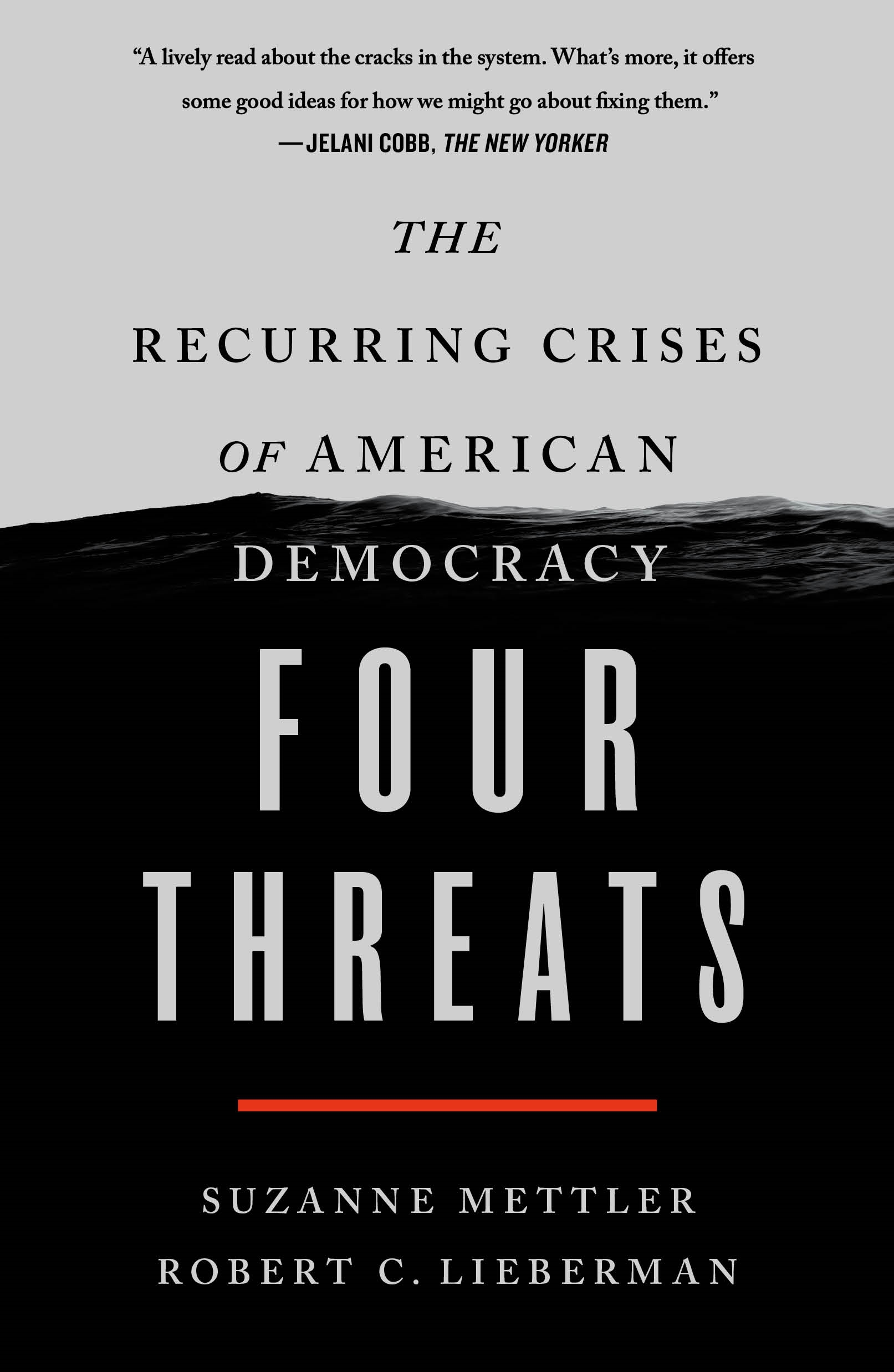
Four Threats An urgent, historically-grounded take on the four major factors that undermine American democracy, and what we can do to address them. While many Americans despair of the current state of U.S. politics, most assume that our system of government and democracy itself are invulnerable to decay. Yet when we examine the past, we find that the United States has undergone repeated crises of democracy, from the earliest days of the republic to the present. In Four Threats, Suzanne Mettler and Robert C. Lieberman explore five moments in history when democracy in the U.S. was under siege: the 1790s, the Civil War, the Gilded Age, the Depression, and Watergate. These episodes risked profound—even fatal—damage to the American democratic experiment. From this history, four distinct characteristics of disruption emerge. Political polarization, racism and nativism, economic inequality, and excessive executive power—alone or in combination—have threatened the survival of the republic, but it has survived—so far. What is unique, and alarming, about the present moment in American politics is that all four conditions exist. This convergence marks the contemporary era as a grave moment for democracy. But history provides a valuable repository from which we can draw lessons about how democracy was eventually strengthened—or weakened—in the past. By revisiting how earlier generations of Americans faced threats to the principles enshrined in the Constitution, we can see the promise and the peril that have led us to today and chart a path toward repairing our civic fabric and renewing democracy. POLITICAL SCIENCE,Political Ideologies,Democracy
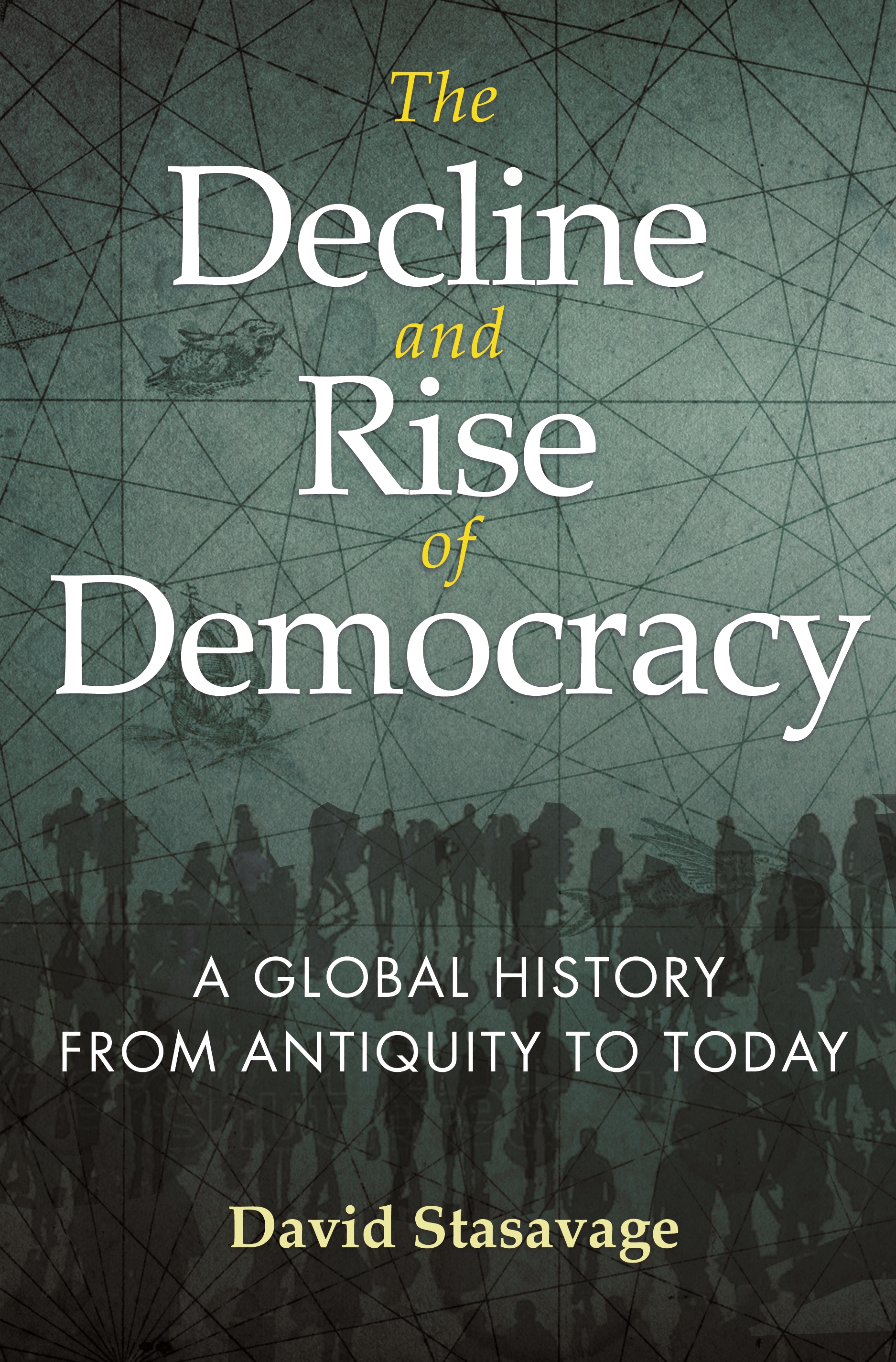
The Decline and Rise of Democracy "One of the most important books on political regimes written in a generation." —Steven Levitsky, New York Times–bestselling author of How Democracies Die A new understanding of how and why early democracy took hold, how modern democracy evolved, and what this teaches us about the future Historical accounts of democracy’s rise tend to focus on ancient Greece and pre-Renaissance Europe. The Decline and Rise of Democracy draws from global evidence to show that the story is much richer—democratic practices were present in many places, at many other times, from the Americas before European conquest, to ancient Mesopotamia, to precolonial Africa. Delving into the prevalence of early democracy throughout the world, David Stasavage makes the case that understanding how and where these democracies flourished—and when and why they declined—can provide crucial information not just about the history of governance, but also about the ways modern democracies work and where they could manifest in the future. Drawing from examples spanning several millennia, Stasavage first considers why states developed either democratic or autocratic styles of governance and argues that early democracy tended to develop in small places with a weak state and, counterintuitively, simple technologies. When central state institutions (such as a tax bureaucracy) were absent—as in medieval Europe—rulers needed consent from their populace to govern. When central institutions were strong—as in China or the Middle East—consent was less necessary and autocracy more likely. He then explores the transition from early to modern democracy, which first took shape in England and then the United States, illustrating that modern democracy arose as an effort to combine popular control with a strong state over a large territory. Democracy has been an experiment that has unfolded over time and across the world—and its transformation is ongoing. Amidst rising democratic anxieties, The Decline and Rise of Democracy widens the historical lens on the growth of political institutions and offers surprising lessons for all who care about governance. POLITICAL SCIENCE,Political Ideologies,Democracy
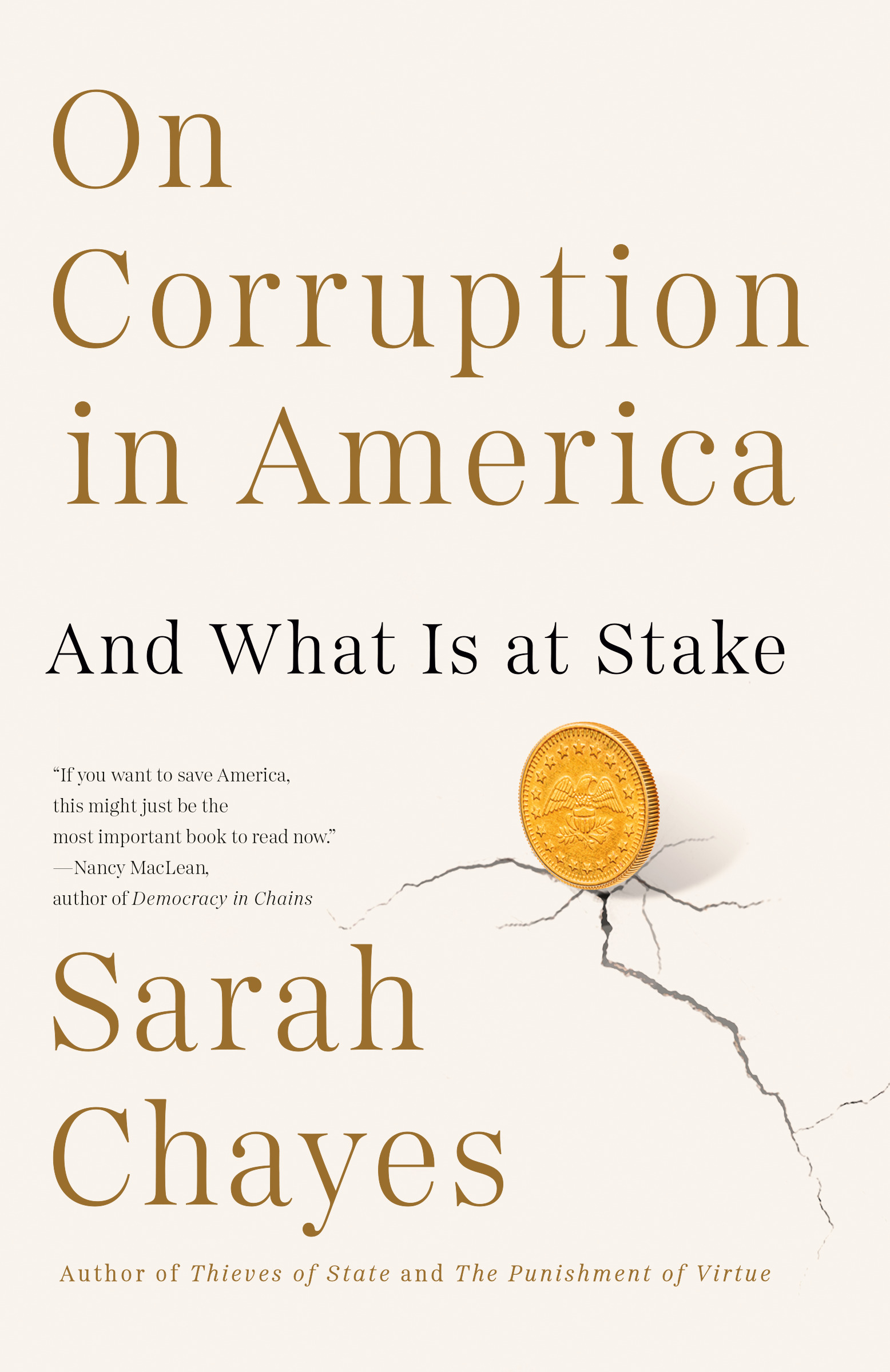
On Corruption in America From the prizewinning journalist, internationally recognized expert on corruption in government networks throughout the world, author of Thieves of State: Why Corruption Threatens Global Security ("I can't imagine a more important book for our time,"--Sebastian Junger; "Required reading,"--Tom Friedman; "compelling, fascinating . . . a call to action,"--The Huffington Post), a major, unflinching book that looks homeward to America, exploring the insidious, dangerous networks of corruption of our past, present, and precarious future. Now, bringing to bear all of her knowledge, grasp, sense of history and observation, Sarah Chayes writes in her new book, that the United States is showing signs similar to some of the most corrupt countries in the world. Corruption, as Chayes sees it, is an operating system of sophisticated networks in which government officials, key private-sector interests, and out-and-out criminals interweave. Their main objective: not to serve the public but to maximize returns for network members. From the titans of America's Gilded Age (Carnegie, Rockefeller, J. P. Morgan, et al.) to the collapse of the stock market in 1929, the Great Depression and FDR's New Deal; from Joe Kennedy's years of banking, bootlegging, machine politics, and pursuit of infinite wealth, as well as the Kennedy presidency, to the deregulation of the Reagan Revolution, undermining the middle class and the unions; from the Clinton policies of political favors and personal enrichment to Trump's hydra-headed network of corruption, systematically undoing the Constitution and our laws, Chayes shows how corrupt systems are organized, how they enforce the rules so their crimes are covered legally, how they are overlooked and downplayed--shrugged off with a roll of the eyes--by the richer and better educated, how they become an overt principle determining the shape of our government, affecting all levels of society. POLITICAL SCIENCE,Political Ideologies,Democracy

Sheldon Wolin and Democracy Lucy Cane presents the first full-length study of Sheldon Wolin (1922–2015), an influential theorist of democracy and prescient critic of "inverted totalitarianism" in the United States. She traces the development of Wolin’s thinking over sixty years, offering an overarching interpretation of his central preoccupations and shifts in perspective. Framed around themes of loss and mourning, this is not only an intellectual biography, but also a critical engagement of Wolin’s work with democratic theory more broadly and an assessment of its value for addressing contemporary crises of democracy. Cane brings Wolin into conversation with other contemporary theorists, from Chantal Mouffe to Edward Said, as well as with his direct intellectual influences. She argues that his mournful tendencies continue to offer unique insight into the potential loss of local democratic cultures in an era of neoliberal precarity. At the same time, she questions whether his politics of mourning can adequately grasp the dynamics of democratic coalition-building or the value of new political movements and ideas. Sheldon Wolin and Democracy remedies a lack of interpretive studies of this key thinker, connects divergent strands of contemporary theory, and addresses urgent democratic dilemmas. It is a must read for all political theorists and others in the academy and beyond who seek to conceptualize the fate of democracy amidst the rise of right-wing populist movements in the twenty-first century. POLITICAL SCIENCE,Political Ideologies,Democracy
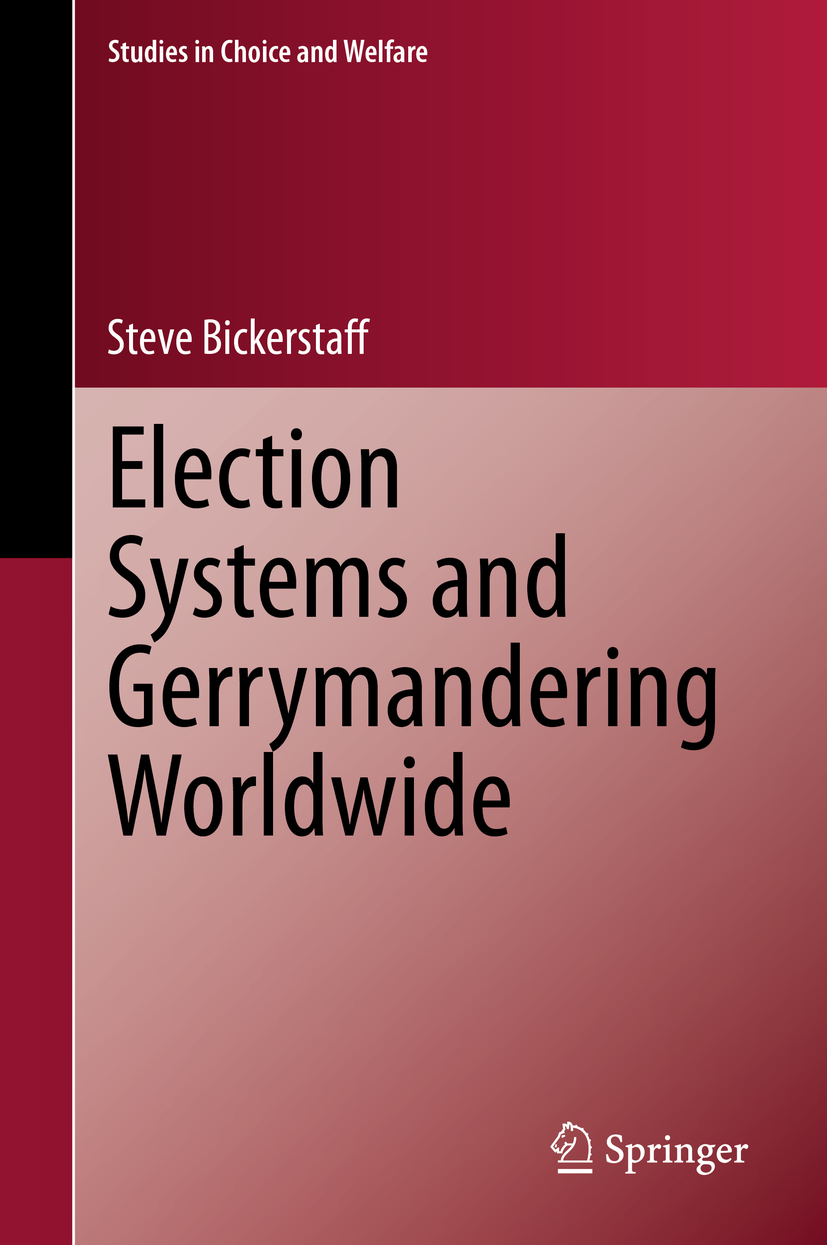
Election Systems and Gerrymandering Worldwide This book explores the similarities and differences among national election systems around the globe and sheds light on how election systems are susceptible to gerrymandering, which is the process by which an incumbent or a political party attempts to manipulate the boundaries of electoral districts for their own advantage. Presenting research showing that some of the worst electoral-system manipulation occurs in the oldest established democracies, the book explores how nations have modified the form of government to meet local conditions and how democracy is threatened by gerrymandering. POLITICAL SCIENCE,Political Ideologies,Democracy
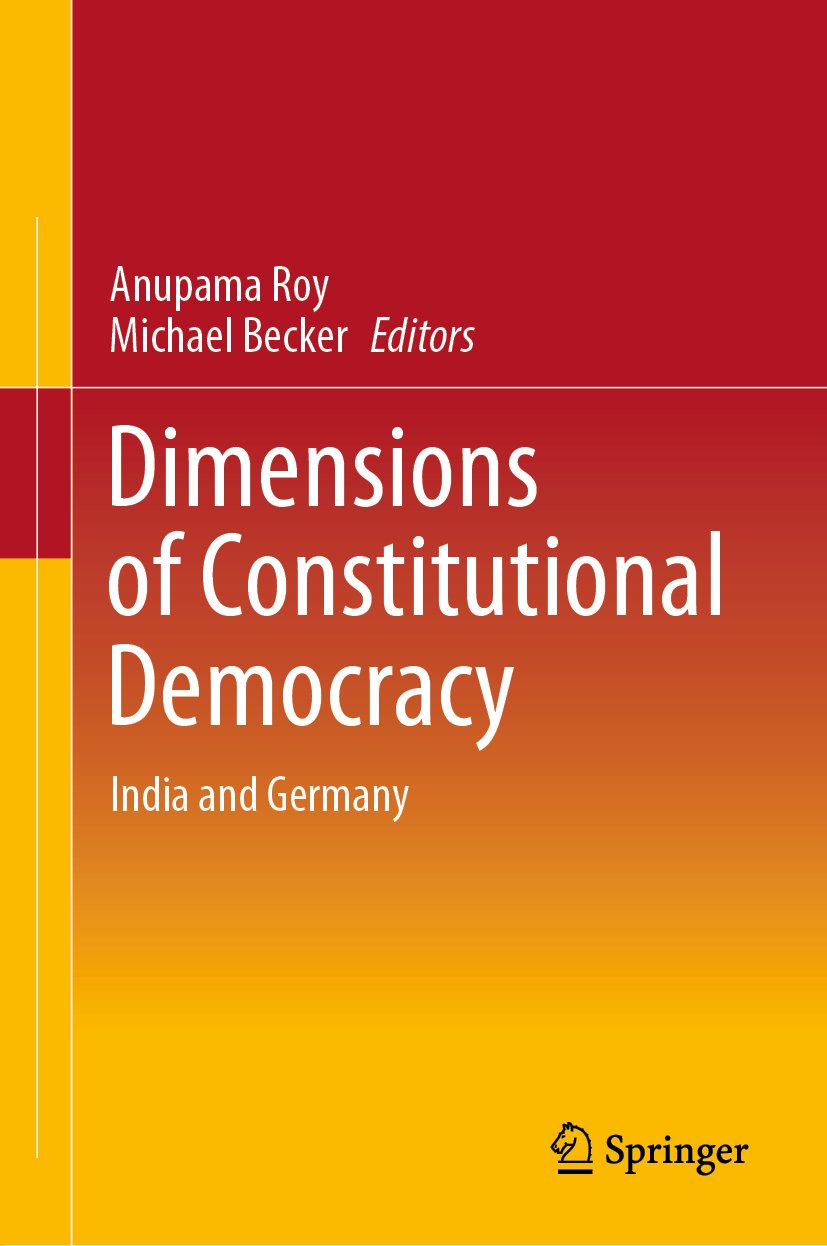
Dimensions of Constitutional Democracy This book examines a selection of themes that have become salient in contemporary debates on constitutional democracies. It focuses in particular on the experiences of India and Germany as examples of post-war and post-colonial constitutional democracies whose trajectories illustrate democratic transitions and transformative constitutionalism. While transformative constitutionalism has come to be associated specifically with the post-apartheid experience in South Africa, this book uses the transformative as an analytical framework to transcend the dichotomy of west and east and explore how temporally coincident constitutions have sought to install constitutional democracies by breaking with the past. While the constitution-making processes in the two countries were specific to their political contexts, the constitutional promises and futures converged. In this context, the book explores the themes of Constitutionalism, Nationalism, Secularism, Sovereignty and Rule of Law, Freedoms and Rights, to investigate how the contestations over democratic transitions and democratic futures have unfolded in the two democracies. It offers readers valuable insights into how the normative frameworks of constitutional democracy take concrete form at specific sites of democratic and constitutional imagination in Dalit and Islamic writings, as well as the relationship between state and religion in the writings of public intellectuals, political and legal philosophers. The book also focuses on specific sites of contestation in democracies including the relationship between sovereignty and citizenship in post-colonial India, free speech and sedition in liberal democracies, questions of land rights in connection with economic and political changes in contemporary contexts, and the rights of indigenous communities with regard to international conventions and domestic law. Given its scope, it will be of interest to students and scholars of political theory, political philosophy, comparative constitutionalism, law and human rights. POLITICAL SCIENCE,Political Ideologies,Democracy

Science in Democracy An argument that draws on canonical and contemporary thinkers in political theory and science studies—from Machiavelli to Latour—for insights on bringing scientific expertise into representative democracy. Public controversies over issues ranging from global warming to biotechnology have politicized scientific expertise and research. Some respond with calls for restoring a golden age of value-free science. More promising efforts seek to democratize science. But what does that mean? Can it go beyond the typical focus on public participation? How does the politics of science challenge prevailing views of democracy? In Science in Democracy, Mark Brown draws on science and technology studies, democratic theory, and the history of political thought to show why an adequate response to politicized science depends on rethinking both science and democracy. Brown enlists such canonical and contemporary thinkers as Machiavelli, Hobbes, Rousseau, Dewey, and Latour to argue that the familiar dichotomy between politics and science reinforces a similar dichotomy between direct democracy and representative government. He then develops an alternative perspective based on the mutual shaping of participation and representation in both science and politics. Political representation requires scientific expertise, and scientific institutions may become sites of political representation. Brown illustrates his argument with examples from expert advisory committees, bioethics councils, and lay forums. Different institutional venues, he shows, mediate different elements of democratic representation. If we understand democracy as an institutionally distributed process of collective representation, Brown argues, it becomes easier to see the politicization of science not as a threat to democracy but as an opportunity for it. POLITICAL SCIENCE,Political Ideologies,Democracy
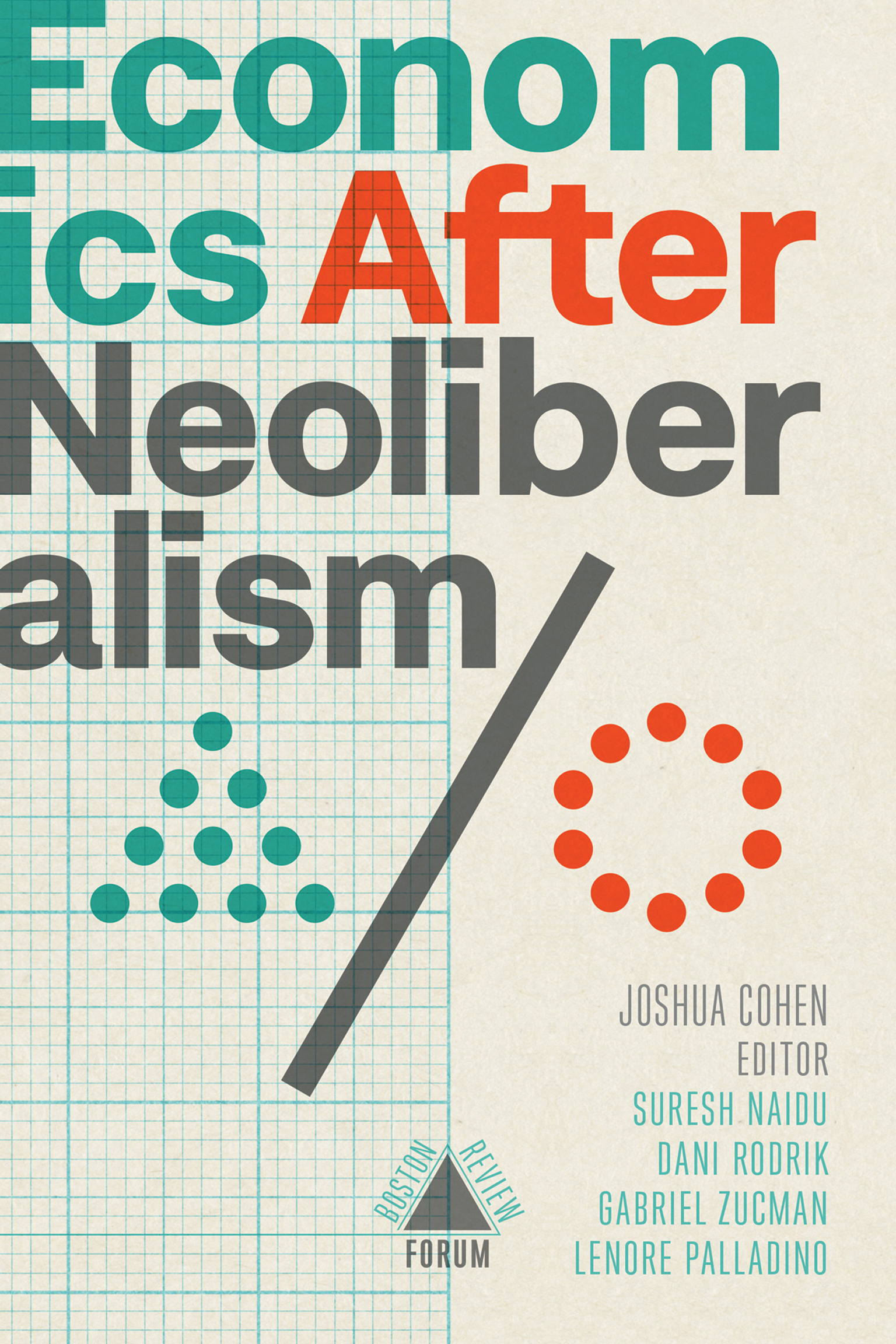
Economics after Neoliberalism How we can look beyond the tyranny of market logic in our public lives to reimagine the fundamentals of democracy. Bringing together thirty-two world-class economists, Economics After Neoliberalism offers a powerful case for a new brand of economics—one focused on power and inequality and aimed at a more inclusive society. Three prominent economists—Suresh Naidu, Dani Rodrik, and Gabriel Zucman—lead off with a vision for economic policy that stands as a genuine alternative to market fundamentalism. Contributors from across the spectrum expand on the state of creative ferment Naidu, Rodrik, and Zucman describe and offer new essays that challenge the current shape of markets and suggest more democratic alternatives. Contributors Samuel Bowles, Ethan Bueno de Mesquita, Oren Cass, William R. Easterly, Alice Evans, Amy Kapczynski, Robert Manduca, Suresh Naidu, Caleb Orr, Lenore Palladino, Margaret Peters, Corey Robin, Dani Rodrik, Debra Satz, Quinn Slobodian, Marshall Steinbaum, Arvind Subramanian, Gabriel Zucman. POLITICAL SCIENCE,Political Ideologies,Democracy

Coding Democracy Hackers as vital disruptors, inspiring a new wave of activism in which ordinary citizens take back democracy. Hackers have a bad reputation, as shady deployers of bots and destroyers of infrastructure. In Coding Democracy, Maureen Webb offers another view. Hackers, she argues, can be vital disruptors. Hacking is becoming a practice, an ethos, and a metaphor for a new wave of activism in which ordinary citizens are inventing new forms of distributed, decentralized democracy for a digital era. Confronted with concentrations of power, mass surveillance, and authoritarianism enabled by new technology, the hacking movement is trying to “build out” democracy into cyberspace. Webb travels to Berlin, where she visits the Chaos Communication Camp, a flagship event in the hacker world; to Silicon Valley, where she reports on the Apple-FBI case, the significance of Russian troll farms, and the hacking of tractor software by desperate farmers; to Barcelona, to meet the hacker group XNet, which has helped bring nearly 100 prominent Spanish bankers and politicians to justice for their role in the 2008 financial crisis; and to Harvard and MIT, to investigate the institutionalization of hacking. Webb describes an amazing array of hacker experiments that could dramatically change the current political economy. These ambitious hacks aim to displace such tech monoliths as Facebook and Amazon; enable worker cooperatives to kill platforms like Uber; give people control over their data; automate trust; and provide citizens a real say in governance, along with capacity to reach consensus. Coding Democracy is not just another optimistic declaration of technological utopianism; instead, it provides the tools for an urgently needed upgrade of democracy in the digital era. POLITICAL SCIENCE,Political Ideologies,Democracy

The Death of Public Knowledge? A collection of short, sharp essays exploring the value of shared and accessible public knowledge in the face of its erosion. The Death of Public Knowledge argues for the value and importance of shared, publicly accessible knowledge, and suggests that the erosion of its most visible forms, including public service broadcasting, education, and the network of public libraries, has worrying outcomes for democracy.With contributions from both activists and academics, this collection of short, sharp essays focuses on different aspects of public knowledge, from libraries and education to news media and public policy. Together, the contributors record the stresses and strains placed upon public knowledge by funding cuts and austerity, the new digital economy, quantification and target-setting, neoliberal politics, and inequality. These pressures, the authors contend, not only hinder democracies, but also undermine markets, economies, and social institutions and spaces everywhere. Covering areas of international public concern, these polemical, accessible texts include reflections on the fate of schools and education, the takeover of public institutions by private interests, and the corruption of news and information in the financial sector. They cover the compromised Greek media during recent EU negotiations, the role played by media and political elites in the Irish property bubble, the compromising of government policy by corporate interests in the United States and Korea, and the squeeze on public service media in the United Kingdom, New Zealand, and the United States.Individually and collectively, these pieces spell out the importance of maintaining public, shared knowledge in all its forms, and offer a rallying cry for doing so, asserting the need for strong public, financial, and regulatory support. Contributors Toril Aalberg, Ian Anstice, Philip Augar, Rodney Benson, Aeron Davis, Des Freedman, Wayne Hope, Ken Jones, Bong-hyun Lee, Colin Leys, Andrew McGettigan, Michael Moran, Aristotelis Nikolaidis, Justin Schlosberg, Henry Silke, Roger Smith, Peter Thompson, Janine R. Wedel, Karel Williams, Kate Wright POLITICAL SCIENCE,Political Ideologies,Democracy
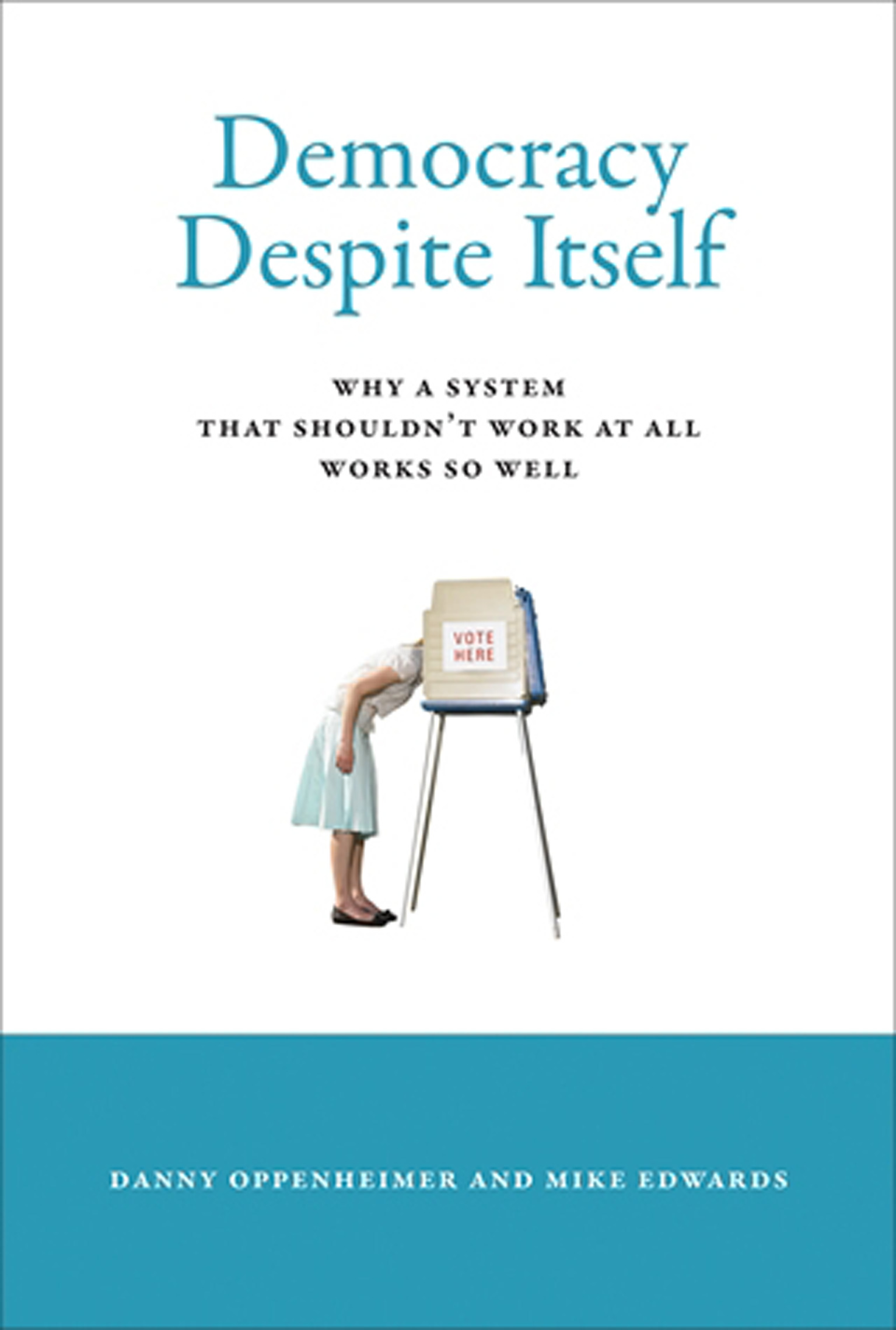
Democracy Despite Itself Why democracy is the most effective form of government despite irrational (and sometime oblivious) voters and flawed (and sometimes inept) politicians. Voters often make irrational decisions based on inaccurate and irrelevant information. Politicians are often inept, corrupt, or out of touch with the will of the people. Elections can be determined by the design of the ballot and the gerrymandered borders of a district. And yet, despite voters who choose candidates according to the boxer–brief dichotomy and politicians who struggle to put together a coherent sentence, democracy works exceptionally well: citizens of democracies are healthier, happier, and freer than citizens of other countries. In Democracy Despite Itself, Danny Oppenheimer, a psychologist, and Mike Edwards, a political scientist, explore this paradox: How can democracy lead to such successful outcomes when the defining characteristic of democracy—elections—is so flawed? Oppenheimer and Edwards argue that democracy works because regular elections, no matter how flawed, produce a variety of unintuitive, positive consequences. The brilliance of democracy, write Oppenheimer and Edwards, does not lie in the people's ability to pick superior leaders. It lies in the many ways that it subtly encourages the flawed people and their flawed leaders to work toward building a better society. POLITICAL SCIENCE,Political Ideologies,Democracy

Fear's Empire "Fear's Empire lays the foundation for a principled opposition based on America's truest and best values."--Senator Gary Hart The author of Jihad vs. McWorld analyzes how American foreign policy has gone wrongand how it could go right. In this hard-hitting but pragmatic new critique of the Bush administration's foreign policy, Benjamin R. Barber exposes in detail the folly of an agenda of preventive war, placing it in the context of two hundred years of American strategic doctrine (including the recent history of deterrence and containment). He shows how chosen "rogue states" have been made to stand in for terrorists too difficult to locate and destroy, and how the United States continues to support dictatorship in nations it regards as friends, while still believing we can impose democracy on vanquished enemies at the barrel of a gun. Barber argues for an America that promotes cooperation, multilateralism, international law, and pooled sovereignty. For as law and citizenship alone secure liberty within nations, law and citizenship alone can secure liberty among them, freeing them from fear. POLITICAL SCIENCE,Political Ideologies,Democracy
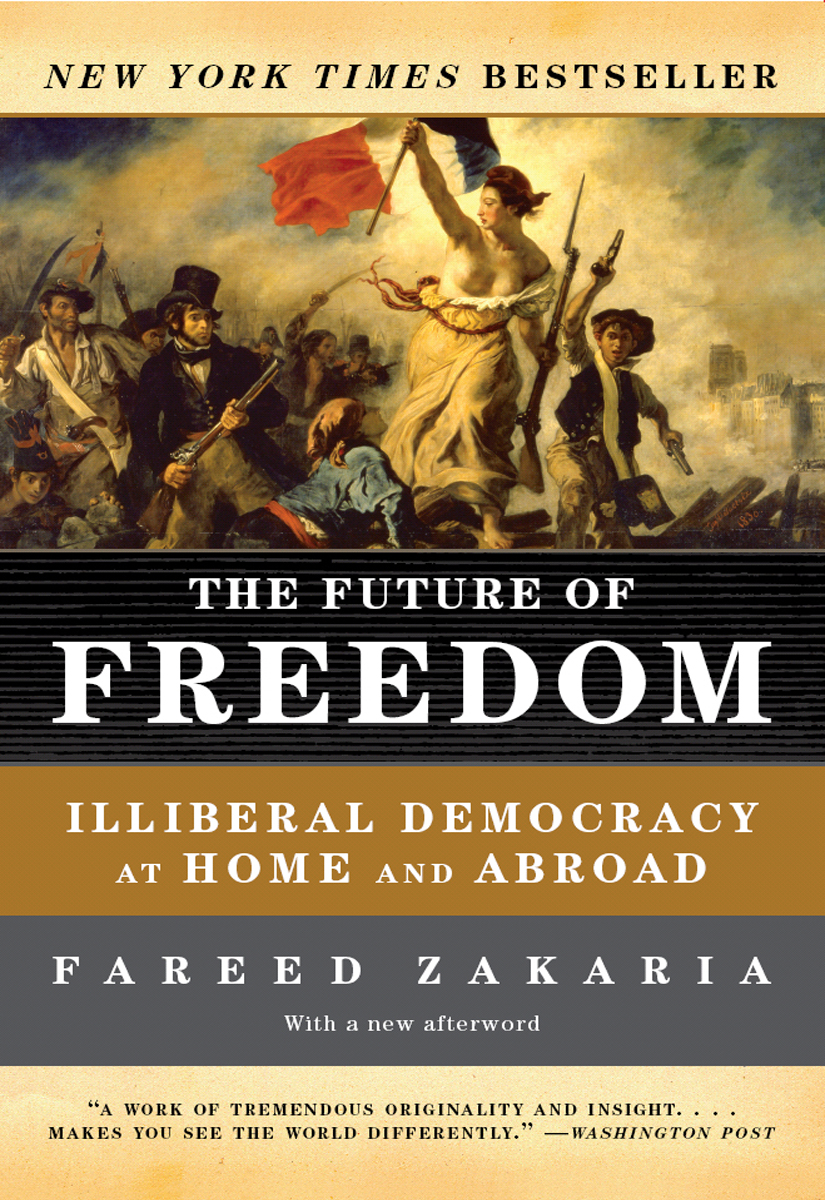
The Future of Freedom “A work of tremendous originality and insight. ... Makes you see the world differently.â€â€”Washington Post Translated into twenty languages ?The Future of Freedom ?is a modern classic that uses historical analysis to shed light on the present, examining how democracy has changed our politics, economies, and social relations. Prescient in laying out the distinction between democracy and liberty, the book contains a new afterword on the United States's occupation of Iraq and a wide-ranging update of the book's themes. POLITICAL SCIENCE,Political Ideologies,Democracy

The Religious Test A manifesto seeking to exhort both believers and atheists to behave better in the public sphere. The Constitution states that “no religious test†may keep a candidate from aspiring to political office. Yet, since John F. Kennedy used the phrase to deflect concerns about his Catholicism, the public has largely avoided probing candidates’ religious beliefs. Is it true, however, that a candidate’s religious convictions should be off-limits to public scrutiny? Damon Linker doesn’t think so, and in this book he outlines the various elements of religious belief—including radical atheism—that are simply incompatible with high office, and sometimes even active citizenship, in a democracy. In six forceful chapters he enlightens us to the complicated interrelations between churches and states, consistently applying a political litmus test to a range of theological views. Along the way, he clearly explains, among other topics, why the government in a religiously tolerant society must not promote a uniform, absolute code of ethics and behavior; why the conviction that America is worthy of divine attention is dangerous; and why the liberal position on the political deregulation of sex is our nation’s only hope for conciliation. In this provocative, hard-hitting manifesto, Linker exhorts both believers and atheists to behave better in the public sphere, and he offers a carefully charted road map for doing so. POLITICAL SCIENCE,Political Ideologies,Democracy

Common Credo The author of America’s Hidden Success launches a daring and appealing political and economic plan to restore American unity and prosperity. Today, bitter partisanship has sunk our politics into unending stalemate, millions of Americans are struggling to get ahead financially, and cynicism about the effectiveness and fairness of our political processes grows continually deeper. The country needs practical, principled, and unifying solutions, rather than continued finger-pointing across the aisle.In Common Credo, acclaimed author John E. Schwarz charts a highly original path out of this morass, one that both liberals and conservatives can rally around. Delving deeply into the words and actions of the Founders themselves, he uncovers a set of core principles involving freedom, equality, and other key values that, despite our surface ideological differences, nearly all Americans still endorse today. When implemented, the principles provide a specific model for how our politics and economy should operate—one that fulfills both conservatives' call for individual liberty with strictly limited government and liberals’ emphasis on collective responsibility and truly sufficient opportunity for all. Schwarz calls this powerful model the "Common Credo." Schwarz then illustrates how this Credo has been abandoned over the past four decades by Democrats and Republicans alike, leading to the political and economic marginalization of a majority of Americans and nearly every political and economic problem we currently face, from the economy’s collapse to the partisan gridlock in Congress. By misunderstanding the Founders’ basic principles, both present-day liberalism and conservatism have helped create the problems and will continue to do so if we don’t find an alternative approach. The Common Credo is that alternative. Only by re-engaging it can we arrive at precise and innovative policy solutions to our most pressing challenges—attaining sustainable economic growth and widespread prosperity; re-empowering the middle class; successfully reforming our health care, education, and campaign finance systems; curbing government waste; and reducing national deficits and debt, among others. Schwarz shows, for example, how applying the logic behind our 1950s tax structure to today's compensation policy can boost middle-class wage gains without raising taxes or spending one cent. Or how combining a carbon-fee plan with targeted rebates can underpin a climate control policy that pays for itself. Laying out these and other solutions in accessible, step-by-step detail, Schwarz engagingly demonstrates how the Common Credo alone holds the key to reuniting Americans and getting us back on the path to success. POLITICAL SCIENCE,Political Ideologies,Democracy
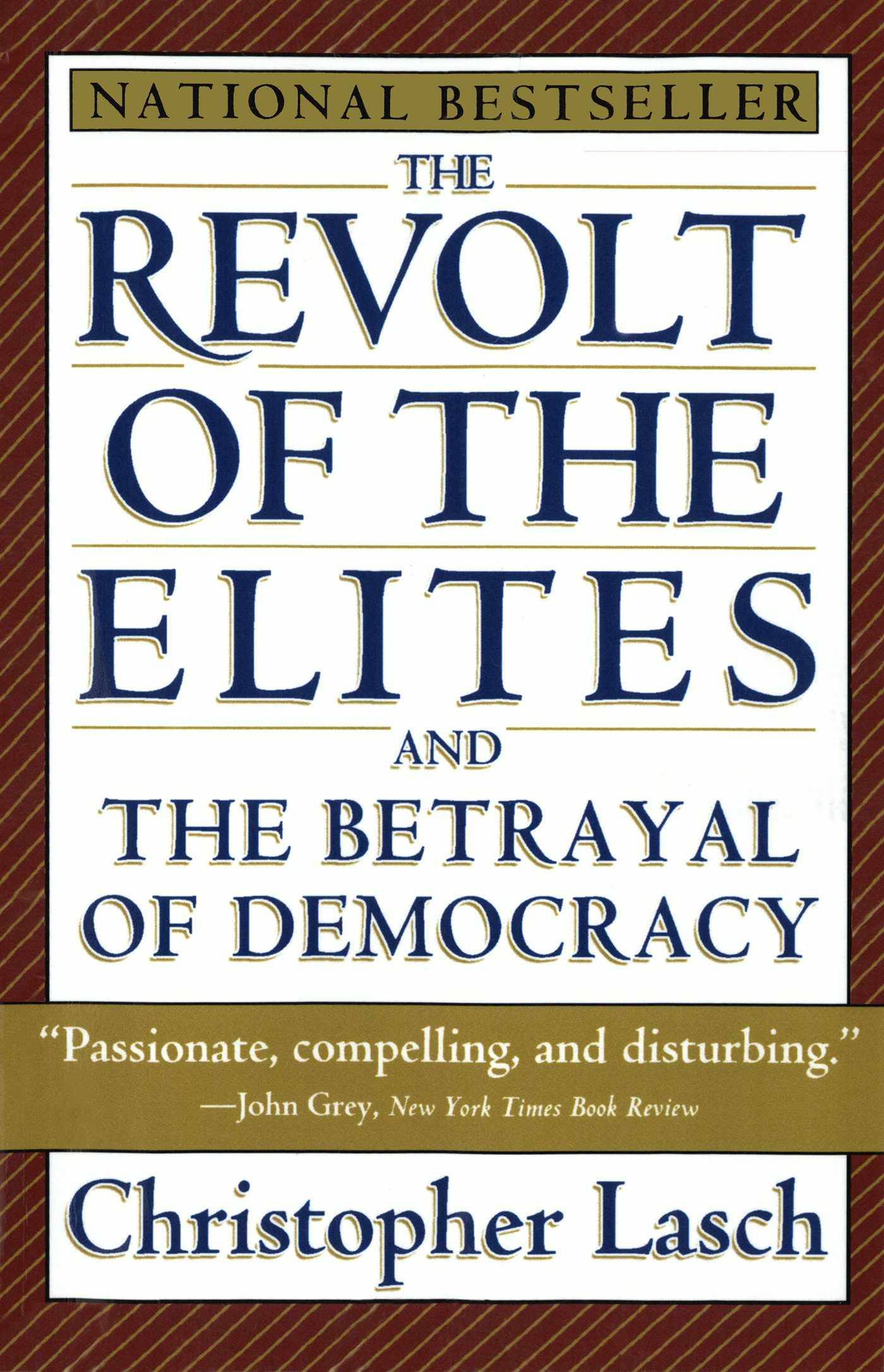
The Revolt of the Elites and the Betrayal of Democracy "[A] passionate, compelling, and disturbing argument that the ills of democracy in the United States today arise from the default of its elites." —John Gray, New York Times Book Review (front-page review) In a front-page review in the Washington Post Book World, John Judis wrote: "Political analysts have been poring over exit polls and precinct-level votes to gauge the meaning of last November's election, but they would probably better employ their time reading the late Christopher Lasch's book." And in the National Review, Robert Bork says The Revolt of the Elites "ranges provocatively [and] insightfully." Controversy has raged around Lasch's targeted attack on the elites, their loss of moral values, and their abandonment of the middle class and poor, for he sets up the media and educational institutions as a large source of the problem. In this spirited work, Lasch calls out for a return to community, schools that teach history not self-esteem, and a return to morality and even the teachings of religion. He does this in a nonpartisan manner, looking to the lessons of American history, and castigating those in power for the ever-widening gap between the economic classes, which has created a crisis in American society. The Revolt of the Elites and the Betrayal of Democracy is riveting social commentary. POLITICAL SCIENCE,Political Ideologies,Democracy

Nature's God Longlisted for the National Book Award. Where did the ideas come from that became the cornerstone of American democracy? America’s founders intended to liberate us not just from one king but from the ghostly tyranny of supernatural religion. Drawing deeply on the study of European philosophy, Matthew Stewart brilliantly tracks the ancient, pagan, and continental ideas from which America’s revolutionaries drew their inspiration. In the writings of Spinoza, Lucretius, and other great philosophers, Stewart recovers the true meanings of “Nature’s God,†“the pursuit of happiness,†and the radical political theory with which the American experiment in self-government began. POLITICAL SCIENCE,Political Ideologies,Democracy

The Dictator's Learning Curve In this riveting anatomy of authoritarianism, acclaimed journalist William Dobson takes us inside the battle between dictators and those who would challenge their rule. Recent history has seen an incredible moment in the war between dictators and democracy—with waves of protests sweeping Syria and Yemen, and despots falling in Egypt, Tunisia, and Libya. But the Arab Spring is only the latest front in a global battle between freedom and repression, a battle that, until recently, dictators have been winning hands-down. The problem is that today’s authoritarians are not like the frozen-in-time, ready-to-crack regimes of Burma and North Korea. They are ever-morphing, technologically savvy, and internationally connected, and have replaced more brutal forms of intimidation with subtle coercion. The Dictator’s Learning Curve explains this historic moment and provides crucial insight into the fight for democracy. POLITICAL SCIENCE,Political Ideologies,Fascism & Totalitarianism

The Dictator's Handbook A groundbreaking new theory of the real rules of politics: leaders do whatever keeps them in power, regardless of the national interest. As featured on the viral video Rules for Rulers, which has been viewed over 3 million times. Bruce Bueno de Mesquita and Alastair Smith's canonical book on political science turned conventional wisdom on its head. They started from a single assertion: Leaders do whatever keeps them in power. They don't care about the "national interest"-or even their subjects-unless they have to. This clever and accessible book shows that democracy is essentially just a convenient fiction. Governments do not differ in kind but only in the number of essential supporters, or backs that need scratching. The size of this group determines almost everything about politics: what leaders can get away with, and the quality of life or misery under them. The picture the authors paint is not pretty. But it just may be the truth, which is a good starting point for anyone seeking to improve human governance. POLITICAL SCIENCE,Political Ideologies,Fascism & Totalitarianism
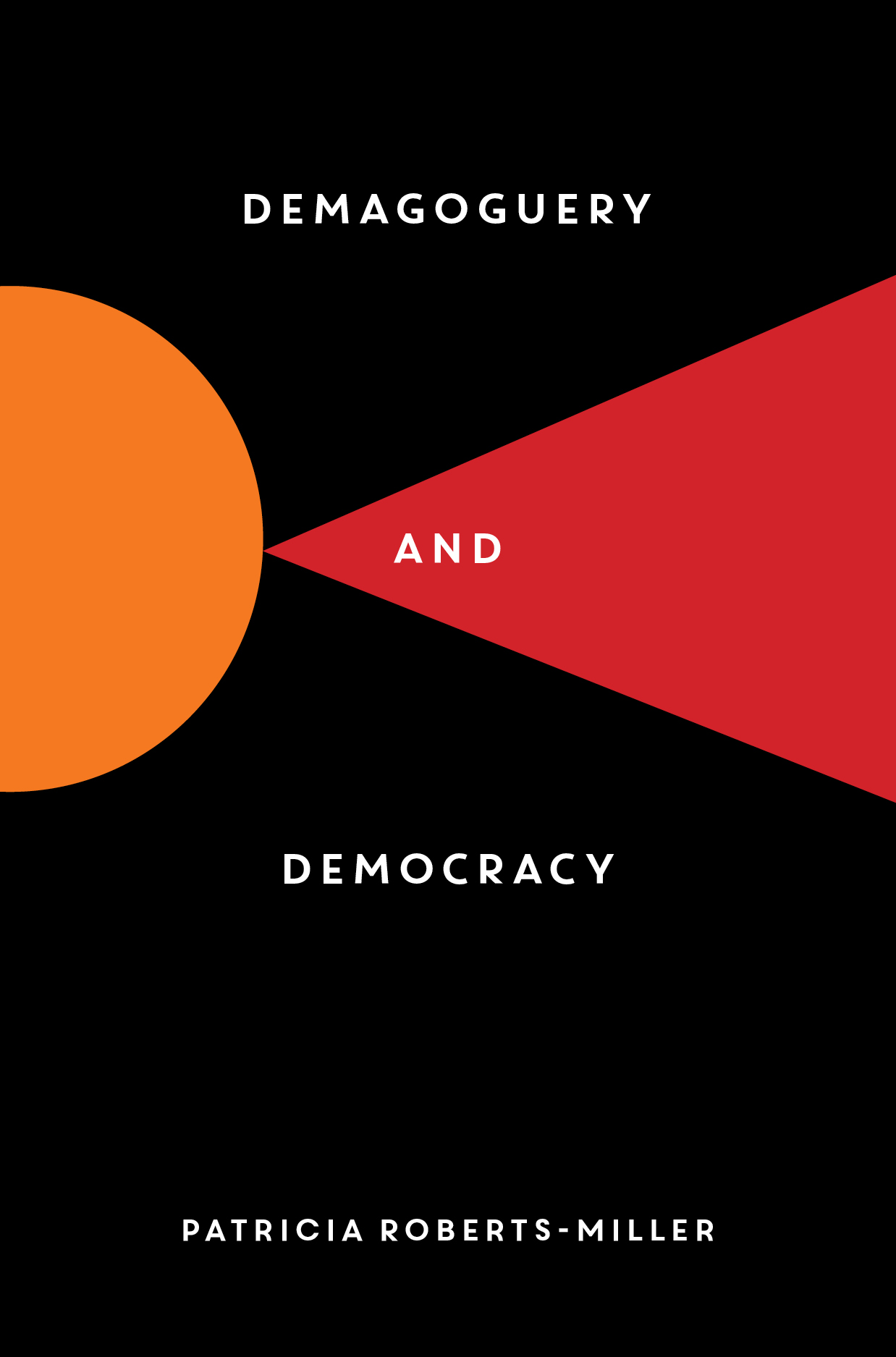
Demagoguery and Democracy Now in paperback: In the vein of On Bullshit, a to-the-point, urgently needed primer to demagoguery from an expert on the subject: what it is, why it’s dangerous, and how we can defeat it POLITICAL SCIENCE,Political Ideologies,Fascism & Totalitarianism

Antifa The National Bestseller “Focused and persuasive... Bray’s book is many things: the first English-language transnational history of antifa, a how-to for would-be activists, and a record of advice from anti-Fascist organizers past and present.”— THE NEW YORKER As long as there has been fascism, there has been anti-fascism — also known as “antifa.” Born out of resistance to Mussolini and Hitler, the antifa movement has suddenly burst into the headlines amidst opposition to the Trump administration and the alt-right. In a smart and gripping investigation, historian and activist Mark Bray provides a detailed survey of the full history of anti-fascism from its origins to the present day — the first transnational history of postwar anti-fascism in English. Today, critics say shutting down political adversaries is anti-democratic; antifa adherents argue that the horrors of fascism must never be allowed the slightest chance to triumph again. Bray amply demonstrates that antifa simply aims to deny fascists the opportunity to promote their oppressive politics, and to protect tolerant communities from acts of violence promulgated by fascists. Based on interviews with anti-fascists from around the world, Antifa details the tactics of the movement and the philosophy behind it, offering insight into the growing but little-understood resistance fighting back against fascism in all its guises. POLITICAL SCIENCE,Political Ideologies,Fascism & Totalitarianism
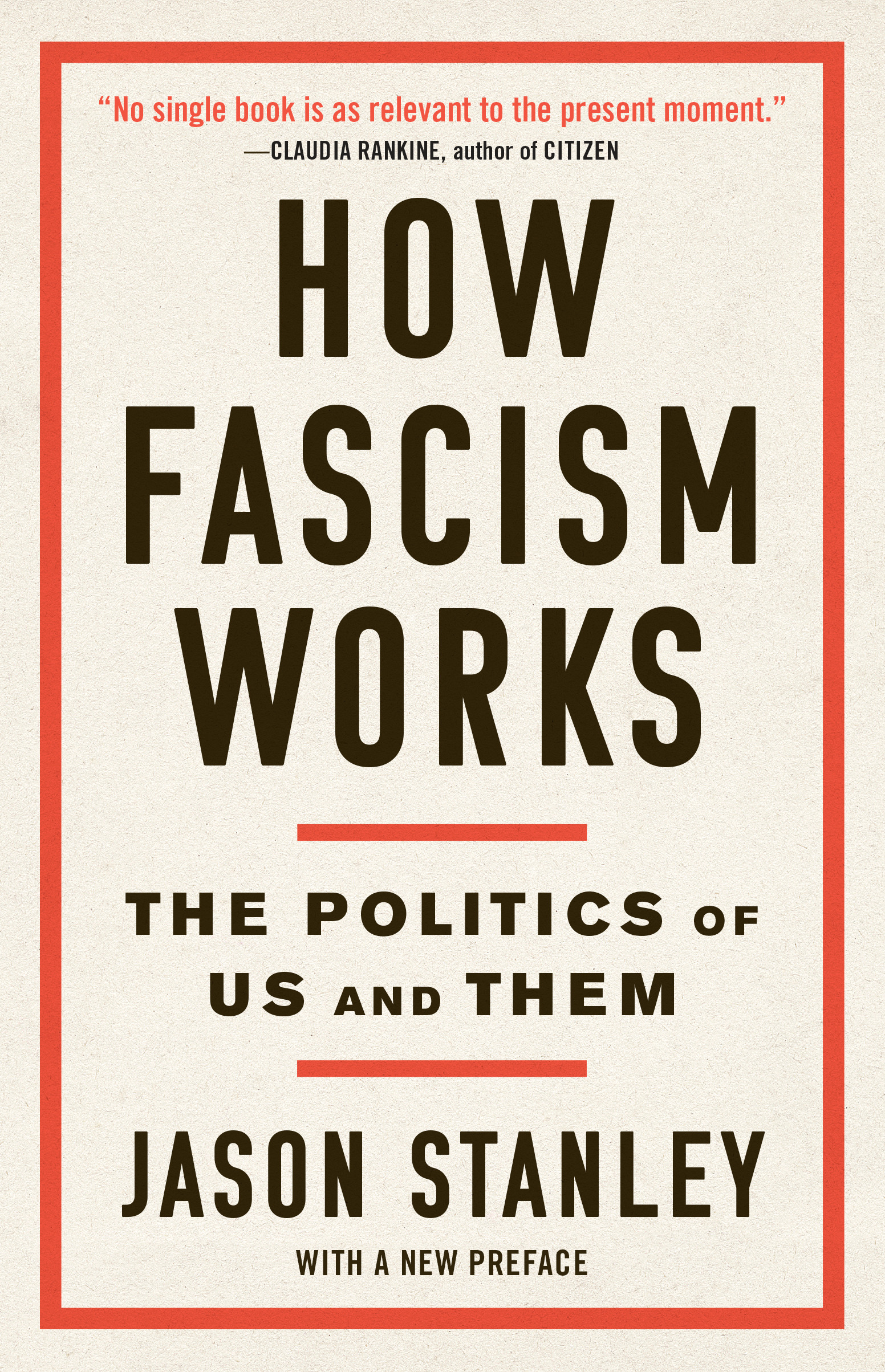
How Fascism Works “A vital read for a nation under Trump.”—The Guardian “No single book is as relevant to the present moment.”—Claudia Rankine, author of Citizen “One of the defining books of the decade.”—Elizabeth Hinton, author of From the War on Poverty to the War on Crime NEW YORK TIMES BOOK REVIEW EDITORS’ CHOICE • Fascist politics are running rampant in America today—and spreading around the world. A Yale philosopher identifies the ten pillars of fascist politics, and charts their horrifying rise and deep history. As the child of refugees of World War II Europe and a renowned philosopher and scholar of propaganda, Jason Stanley has a deep understanding of how democratic societies can be vulnerable to fascism: Nations don’t have to be fascist to suffer from fascist politics. In fact, fascism’s roots have been present in the United States for more than a century. Alarmed by the pervasive rise of fascist tactics both at home and around the globe, Stanley focuses here on the structures that unite them, laying out and analyzing the ten pillars of fascist politics—the language and beliefs that separate people into an “us” and a “them.” He knits together reflections on history, philosophy, sociology, and critical race theory with stories from contemporary Hungary, Poland, India, Myanmar, and the United States, among other nations. He makes clear the immense danger of underestimating the cumulative power of these tactics, which include exploiting a mythic version of a nation’s past; propaganda that twists the language of democratic ideals against themselves; anti-intellectualism directed against universities and experts; law and order politics predicated on the assumption that members of minority groups are criminals; and fierce attacks on labor groups and welfare. These mechanisms all build on one another, creating and reinforcing divisions and shaping a society vulnerable to the appeals of authoritarian leadership. By uncovering disturbing patterns that are as prevalent today as ever, Stanley reveals that the stuff of politics—charged by rhetoric and myth—can quickly become policy and reality. Only by recognizing fascists politics, he argues, may we resist its most harmful effects and return to democratic ideals. “With unsettling insight and disturbing clarity, How Fascism Works is an essential guidebook to our current national dilemma of democracy vs. authoritarianism.”—William Jelani Cobb, author of The Substance of Hope POLITICAL SCIENCE,Political Ideologies,Fascism & Totalitarianism

The Big Lie "Of course, everything [D'Souza] says here is accurate... But it's not going to sit well with people on the American left who, of course, are portraying themselves as the exact opposite of all of this." —RUSH LIMBAUGH The explosive new book from Dinesh D'Souza, author of the #1 New York Times bestsellers Hillary's America, America, and Obama's America. What is "the big lie" of the Democratic Party? That conservatives—and President Donald Trump in particular—are fascists. Nazis, even. In a typical comment, MSNBC host Rachel Maddow says the Trump era is reminiscent of "what it was like when Hitler first became chancellor." But in fact, this audacious lie is a complete inversion of the truth. Yes, there is a fascist threat in America—but that threat is from the Left and the Democratic Party. The Democratic left has an ideology virtually identical with fascism and routinely borrows tactics of intimidation and political terror from the Nazi Brownshirts. To cover up their insidious fascist agenda, Democrats loudly accuse President Trump and other Republicans of being Nazis—an obvious lie, considering the GOP has been fighting the Democrats over slavery, genocide, racism and fascism from the beginning. Now, finally, Dinesh D'Souza explodes the Left's big lie. He expertly exonerates President Trump and his supporters, then uncovers the Democratic Left's long, cozy relationship with Nazism: how the racist and genocidal acts of early Democrats inspired Adolf Hitler's campaign of death; how fascist philosophers influenced the great 20th century lions of the American Left; and how today's anti-free speech, anti-capitalist, anti-religious liberty, pro-violence Democratic Party is a frightening simulacrum of the Nazi Party. Hitler coined the term "the big lie" to describe a lie that "the great masses of the people" will fall for precisely because of how bold and monstrous the lie is. In The Big Lie, D'Souza shows that the Democratic Left's orchestrated campaign to paint President Trump and conservatives as Nazis to cover up its own fascism is, in fact, the biggest lie of all. POLITICAL SCIENCE,Political Ideologies,Fascism & Totalitarianism

Germans Against Nazism Rather than being accepted by all of German society, the Nazi regime was resisted in both passive and active forms. This re-issued volume examines opposition to National Socialism by Germans during the Third Reich in its broadest sense. It considers individual and organized nonconformity, opposition, and resistance ranging from symbolic acts of disobedience to organized assassination attempts, and looks at how disparate groups such as the Jewish community, churches, conservatives, communists, socialists, and the military all defied the regime in their own ways. POLITICAL SCIENCE,Political Ideologies,Fascism & Totalitarianism

Fascist Interactions Although studies of fascism have constituted one of the most fertile areas of historical inquiry in recent decades, more and more scholars have called for a new agenda with more research beyond Italy and Germany, less preoccupation with definition and classification, and more sustained focus on the relationships among different fascist formations before 1945. Starting from a critical assessment of these imperatives, this rigorous volume charts a historiographical path that transcends rigid distinctions while still developing meaningful criteria of differentiation. Even as we take fascism seriously as a political phenomenon, such an approach allows us to better understand its distinctive contradictions and historical variations. POLITICAL SCIENCE,Political Ideologies,Fascism & Totalitarianism
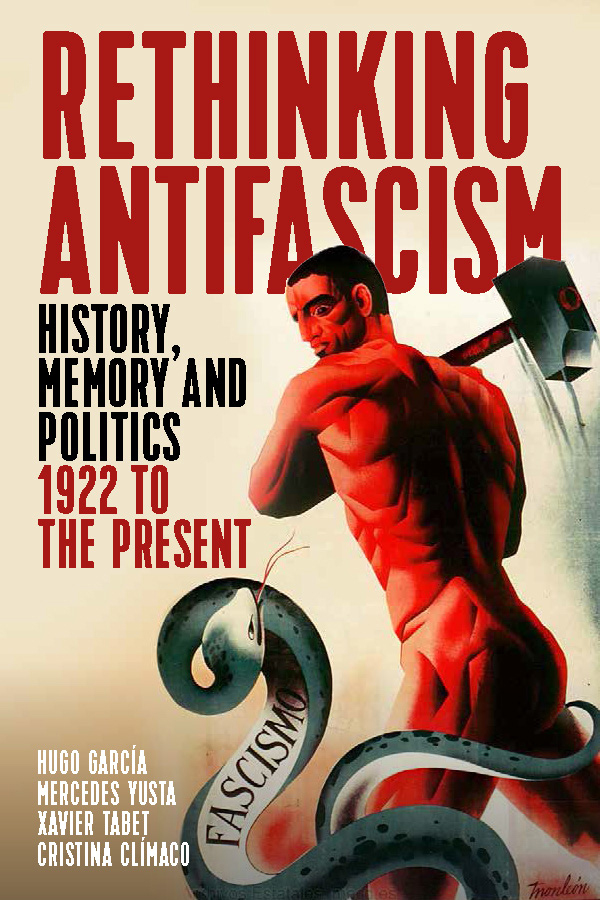
Rethinking Antifascism Bringing together leading scholars from a range of nations, Rethinking Antifascism provides a fascinating exploration of one of the most vibrant sub-disciplines within recent historiography. Through case studies that exemplify the field’s breadth and sophistication, it examines antifascism in two distinct realms: after surveying the movement’s remarkable diversity across nations and political cultures up to 1945, the volume assesses its postwar political and ideological salience, from its incorporation into Soviet state doctrine to its radical questioning by historians and politicians. Avoiding both heroic narratives and reflexive revisionism, these contributions offer nuanced perspectives on a movement that helped to shape the postwar world. POLITICAL SCIENCE,Political Ideologies,Fascism & Totalitarianism

Fascism without Borders It is one of the great ironies of the history of fascism that, despite their fascination with ultra-nationalism, its adherents understood themselves as members of a transnational political movement. While a true “Fascist International†has never been established, European fascists shared common goals and sentiments as well as similar worldviews. They also drew on each other for support and motivation, even though relations among them were not free from misunderstandings and conflicts. Through a series of fascinating case studies, this expansive collection examines fascism’s transnational dimension, from the movements inspired by the early example of Fascist Italy to the international antifascist organizations that emerged in subsequent years. POLITICAL SCIENCE,Political Ideologies,Fascism & Totalitarianism
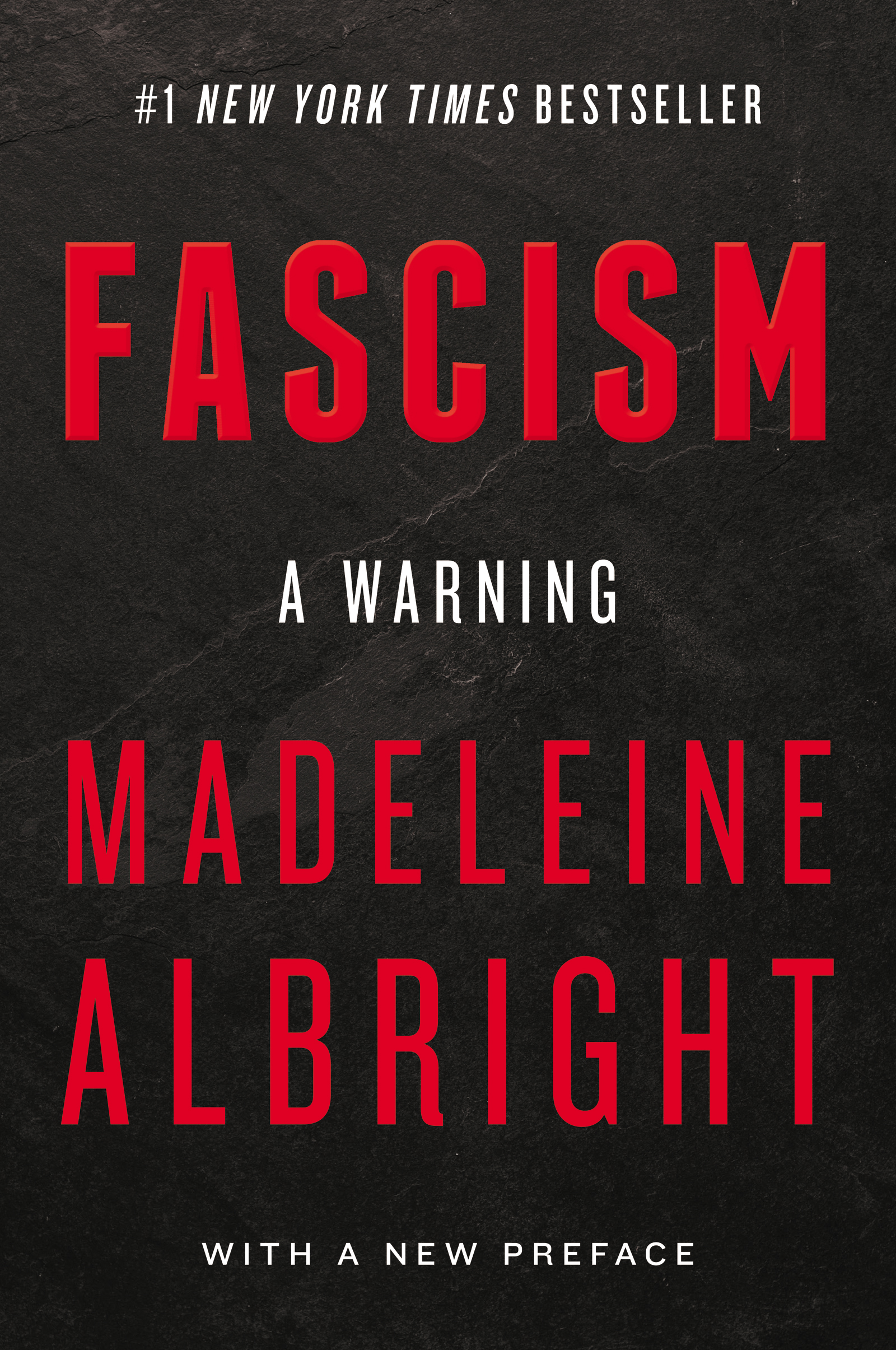
Fascism #1 New York Times Bestseller Best Books of 2018 --The Economist A personal and urgent examination of Fascism in the twentieth century and how its legacy shapes today’s world, written by one of America’s most admired public servants, the first woman to serve as U.S. secretary of state A Fascist, observes Madeleine Albright, “is someone who claims to speak for a whole nation or group, is utterly unconcerned with the rights of others, and is willing to use violence and whatever other means are necessary to achieve the goals he or she might have.†The twentieth century was defined by the clash between democracy and Fascism, a struggle that created uncertainty about the survival of human freedom and left millions dead. Given the horrors of that experience, one might expect the world to reject the spiritual successors to Hitler and Mussolini should they arise in our era. In Fascism: A Warning, Madeleine Albright draws on her experiences as a child in war-torn Europe and her distinguished career as a diplomat to question that assumption. Fascism, as she shows, not only endured through the twentieth century but now presents a more virulent threat to peace and justice than at any time since the end of World War II. The momentum toward democracy that swept the world when the Berlin Wall fell has gone into reverse. The United States, which historically championed the free world, is led by a president who exacerbates division and heaps scorn on democratic institutions. In many countries, economic, technological, and cultural factors are weakening the political center and empowering the extremes of right and left. Contemporary leaders such as Vladimir Putin and Kim Jong-un are employing many of the tactics used by Fascists in the 1920s and 30s. Fascism: A Warning is a book for our times that is relevant to all times. Written by someone who has not only studied history but helped to shape it, this call to arms teaches us the lessons we must understand and the questions we must answer if we are to save ourselves from repeating the tragic errors of the past. POLITICAL SCIENCE,Political Ideologies,Fascism & Totalitarianism

The Fight for the Soul of the Democratic Party Fighting fascism at home and abroad begins with the consolidation of a progressive politics Seventy-five years ago, Henry Wallace, then the sitting Vice President of the United States, mounted a campaign to warn about the persisting "Danger of American Fascism." As fighting in the European and Japanese theaters drew to a close, Wallace warned that the country may win the war and lose the piece; that the fascist threat that the U.S. was battling abroad had a terrifying domestic variant, growing rapidly in power: wealthy corporatists and their allies in the media. Wallace warned that if the New Deal project was not renewed and expanded in the post-war era, American fascists would use fear mongering, xenophonbia, and racism to regain the economic and political power that they lost. He championed an alternative, progressive vision of a post-war world-an alternative to triumphalist "American Century" vision then rising--in which the United States rejected colonialism and imperialism. Wallace's political vision - as well as his standing in the Democratic Party - were quickly sidelined. In the decades to come, other progressive forces would mount similar campaigns: George McGovern and Jesse Jackson more prominently. As John Nichols chronicles in this book, they ultimately failed - a warning to would-be reformers today - but their successive efforts provide us with insights into the nature of the Democratic Party, and a strategic script for the likes of Bernie Sanders and Alexandria Ocasio-Cortez. POLITICAL SCIENCE,Political Ideologies,Fascism & Totalitarianism
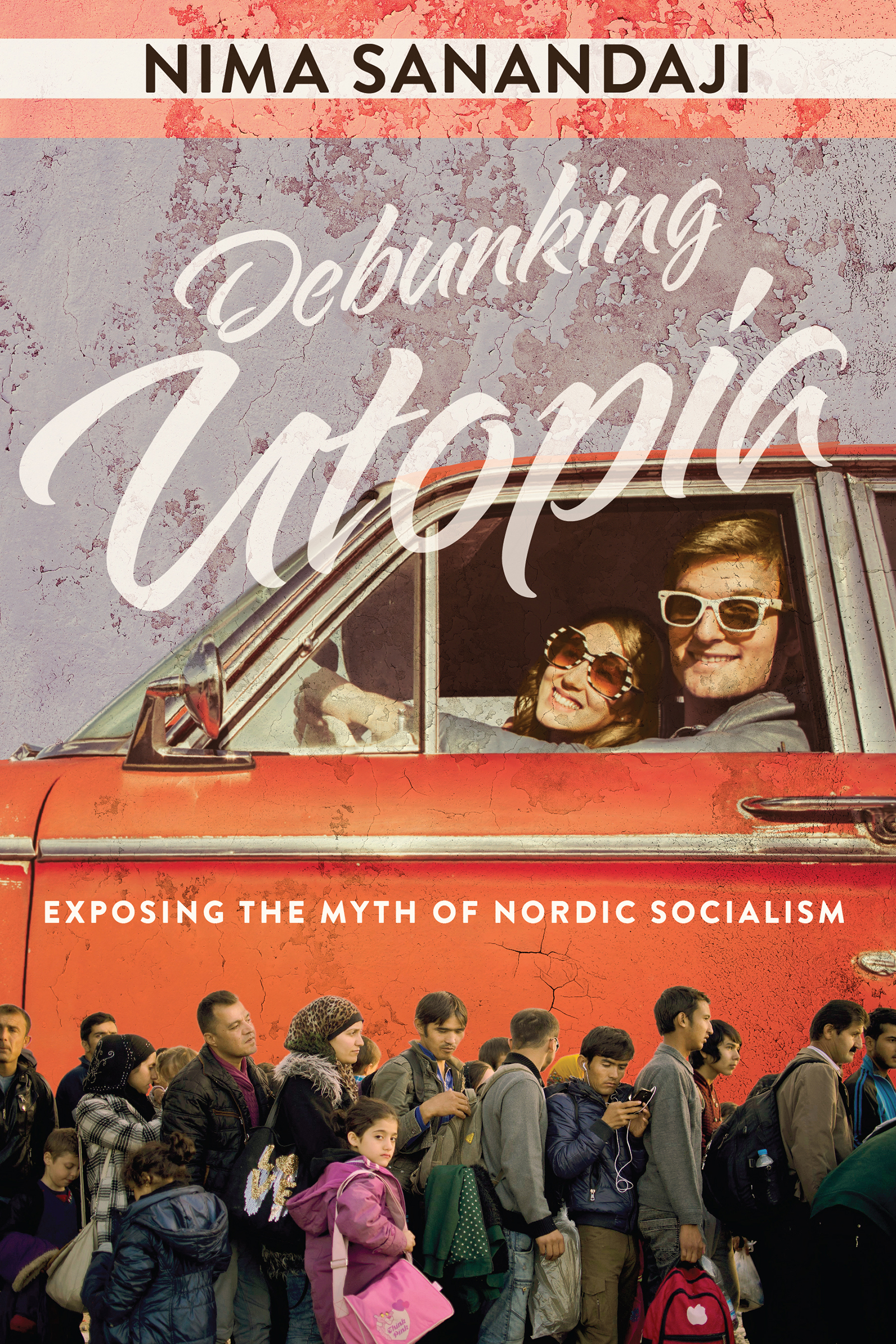
Debunking Utopia Left-leaning academics, liberal pop stars such as Bruce Springsteen, and Democrat politicians from Bernie Sanders to Bill and Hillary Clinton to Barack Obama all have one thing in common: they are avid admirers of Nordic-style social democracy. The reason is simple. At first glance, Nordic countries seem to have everything liberals want to see in America: equal income distribution, good health, low levels of poverty, and thriving economies, all co-existing with big welfare states. By copying Nordic policies, many in the American left hope to transform America to a similar socialist "utopia." In Debunking Utopia , Swedish author Nima Sanandaji explains why this is all wishful thinking. Certainly, some aspects of Nordic welfare states, such as childcare provision, merit the admiration of liberals. But overall, it is a unique culture based on hard work, healthy diets, social cohesion and high levels of trust that have made Nordic countries successful. Sanandaji explains how the Nordic people adopted this culture of success in order to survive in the unforgiving Scandinavian climate. He systematically proves that the high levels of income equality, high lifespans and other signs of social success in the Nordics all predate the expansion of the welfare state. If anything, the Nordic countries reached their peak during the mid-twentieth century, when they had low taxes and small welfare states. Perhaps most astonishing are his findings that Nordic-Americans consistently outperform their cousins who live across the ocean. People of Nordic descent who live under the American capitalist system not only enjoy higher levels of income, but also a lower level of poverty than the citizens of the Nordic countries themselves. Sanandaji's previous writings on the roots of Nordic success have gained media attention around the world and been translated into many languages. Debunking Utopia, which expands on this work, should be read by all—liberals and conservatives alike—who follow the debate over the future of American welfare. As Sanandaji shows, there is much Americans can learn from both the successes and failures of Nordic-style social democracy. POLITICAL SCIENCE,Political Ideologies,Fascism & Totalitarianism

How to Be a Fascist The first and only guide to turning your 21st century democracy into a fascist paradise. Democracy is difficult, flawed and unstable. It involves barely distinguishable political parties taking part in lengthy, overcomplicated and expensive decision-making processes. Trying to engage so many people with political issues seems to lead only to complexity and disagreement. So why bother? Doesn't fascism guarantee a more effective and efficient management of the state? In this short, bitingly ironic mixture of On Tyranny and The Psychopath Test, Italian political activist Michela Murgia explores the logic that is attracting increasing numbers of voters to right-wing populism. Far from its origins in the 20th century, fascism is once again on the rise in an age of increased connectivity and globalism. Murgia shows how many of the elements of our society that we might think would combat closed-mindedness and xenophobia actually fan the flames. Closing with a "fascistometer" to measure the reader's own authoritarian inclinations, How to be a Fascist is a refreshingly direct, polemical book that asks us to confront the fascisim in our governments, in our societies, and in our own political leanings. POLITICAL SCIENCE,Political Ideologies,Fascism & Totalitarianism

American Antifa Since the election of President Trump and the rise in racist and white supremacist activity, the militant antifascist movement known as antifa has become increasingly active and high profile in the United States. This book analyzes the tactics, culture, and practices of the movement through a combination of social movement studies and critical criminological perspectives. Based on extensive fieldwork and interviews with activists, this book is the first scholarly sociological analysis of contemporary antifascist activism in the United States. Drawing on social movement studies, subculture studies and critical criminology, it explains antifa's membership, their ideology, strategy, tactics and use of culture as a weapon against the far right. It provides the most detailed account of this movement and also cuts through much of the mythology and common misunderstandings about it. This book will be of interest to scholars and students in sociology, political science, anthropology, criminology, and history; however, a general audience would also be interested in the explanation of what drives antifa tactics and strategy in light of the high-profile conflicts between fascists and antifascists. POLITICAL SCIENCE,Political Ideologies,Fascism & Totalitarianism
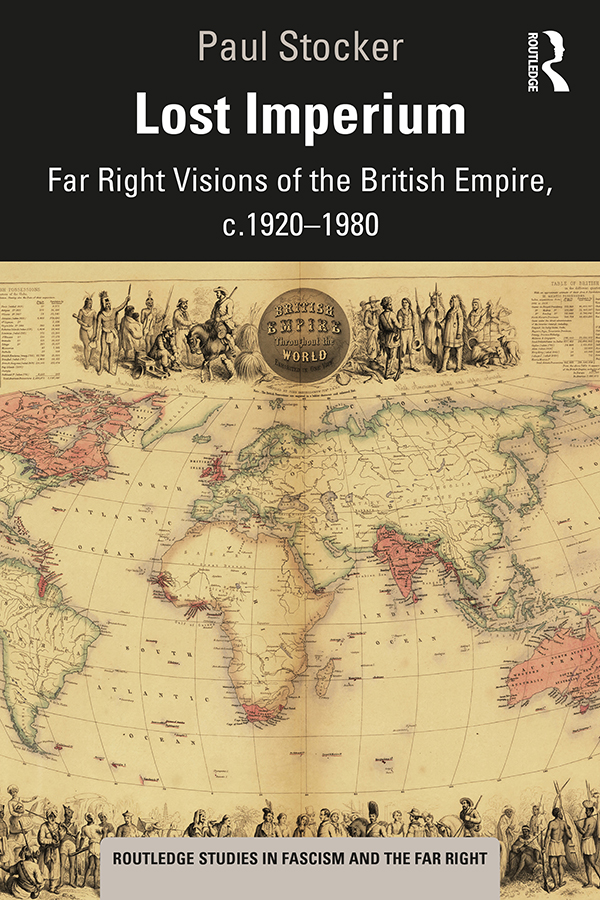
Lost Imperium This book examines, for the first time, the role of Britain's Empire in far right thought between 1920 and 1980. Throughout these turbulent decades, upheaval in the Empire, combined with declining British world power, was frequently discussed and reflected upon in far right publications, as were radical policies designed to revitalise British imperialism. Drawing on the case studies of Ireland, India, Palestine, Kenya and Rhodesia, Lost Imperium argues that imperialism provided a frame through which ideas at the core of far right thinking could be advocated: nationalism, racism, conspiracy theory, antisemitism and anti-communism. The far right's opposition to imperial decline ultimately reflected more than just a desire to reverse the fortunes of the British Empire, it was also a crucial means of promoting central ideological values. By analysing far right imperial thought, we are able to understand how they interacted with mainstream ideas of British imperialism during the twentieth century, while also promoting their own uniquely racist, violent and authoritarian vision of Empire. This book will be of interest to students and scholars of British fascism, empire, imperialism, racial and ethnic studies, and political history. POLITICAL SCIENCE,Political Ideologies,Fascism & Totalitarianism

The Rise of the Dutch New Right In the past 20 years, a wave of right-wing populist movements has swept over Europe, changing the face of European politics. The Netherlands has been one of the more iconic countries to partake in this shift. Known internationally as an emblem of progressivism and tolerance, the country soon became a frontrunner in the revival of nationalist and anti-immigrant sentiment. This is the first study to offer an extensive engagement with the ideas behind the Dutch swing to the right. The emergence of Dutch populism, this book shows, formed an integral part of a broader conservative tendency, identified as the Dutch New Right. In the US and the UK, the term New Right has been used to describe conservative backlash movements that arose in opposition to the progressive movements of the 1960s. The Dutch swing to the right, this book argues, formed a belated iteration of the New Right backlash that occurred overseas. This text will be essential reading for students and scholars in the fields of European Studies and Political Science, and Dutch politics and society more specifically. POLITICAL SCIENCE,Political Ideologies,Fascism & Totalitarianism

The Prince The Prince Here is the world’s most famous master plan for seizing and holding power. Astonishing in its candor, The Prince even today remains a disturbingly realistic and prophetic work on what it takes to be a prince...a king...a president. When, in 1512, Machiavelli was removed from his post in his beloved Florence, he resolved to set down a treatise on leadership that was practical, not idealistic. The prince he envisioned would be unencumbered by ordinary ethical and moral values; his prince would be man and beast, fox and lion. Today this small sixteenth-century masterpiece has become essential reading for every student of government and is the ultimate book on power politics. This Bantam Classic edition of The Prince includes selections from Machiavelli’s Discourses as well as an introduction and notes by the translator, Daniel Donno. POLITICAL SCIENCE,Political Ideologies,General
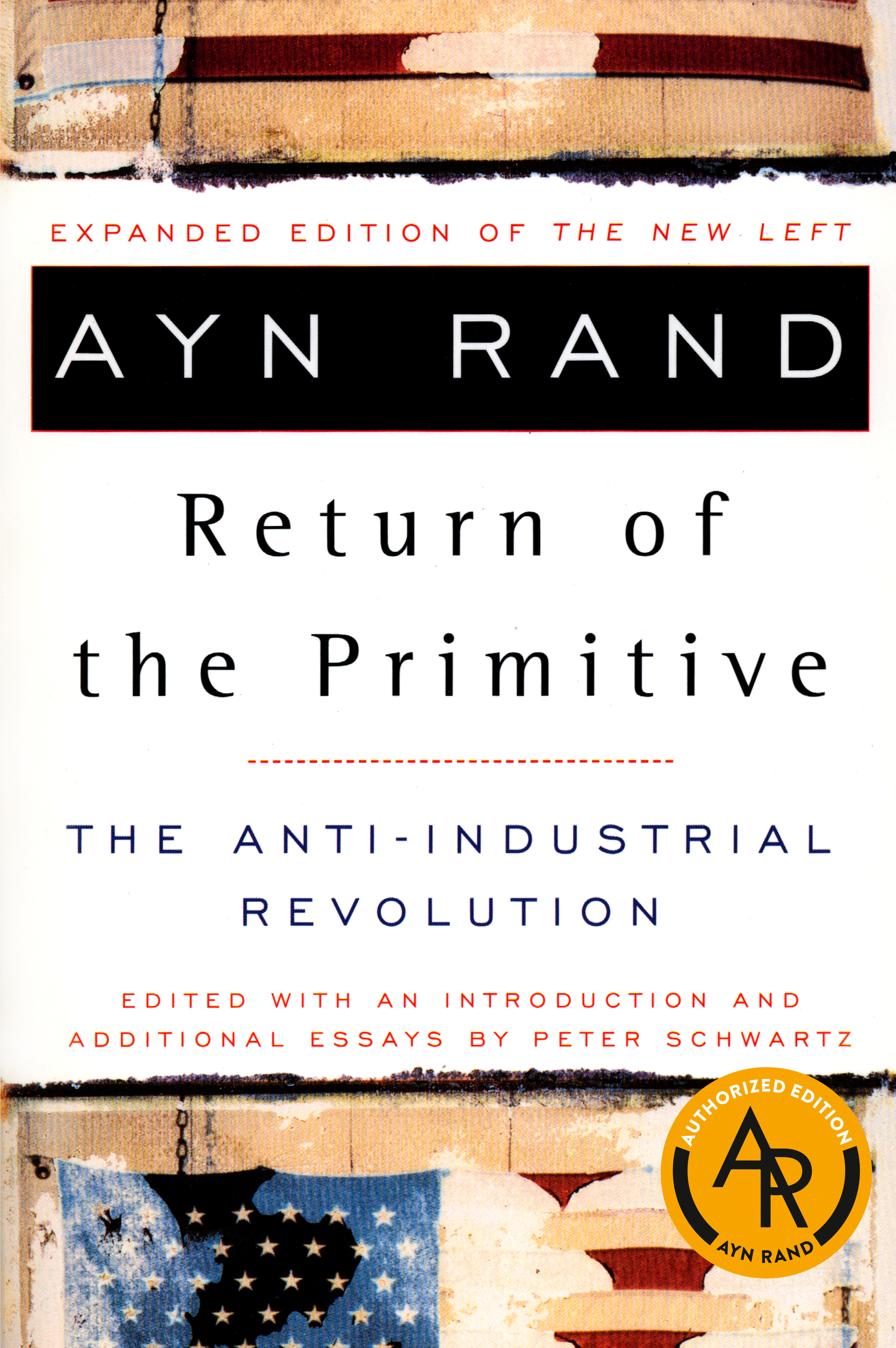
The Return of the Primitive In the tumultuous late 60s and early 70s, a social movement known as the "New Left" emerged as a major cultural influence, especially on the youth of America. It was a movement that embraced "flower-power" and psychedelic "consciousness-expansion," that lionized Ho Chi Minh and Fidel Castro and launched the Black Panthers and the Theater of the Absurd.In Return Of The Primitive (originally published in 1971 as The New Left), Ayn Rand, bestselling novelist and originator of the theory of Objectivism, identified the intellectual roots of this movement. She urged people to repudiate its mindless nihilism and to uphold, instead, a philosophy of reason, individualism, capitalism, and technological progress.Editor Peter Schwartz, in this new, expanded version of The New Left, has reorganized Rand's essays and added some of his own in order to underscore the continuing relevance of her analysis of that period. He examines such current ideologies as feminism, environmentalism and multiculturalism and argues that the same primitive, tribalist, "anti-industrial" mentality which animated the New Left a generation ago is shaping society today. POLITICAL SCIENCE,Political Ideologies,General
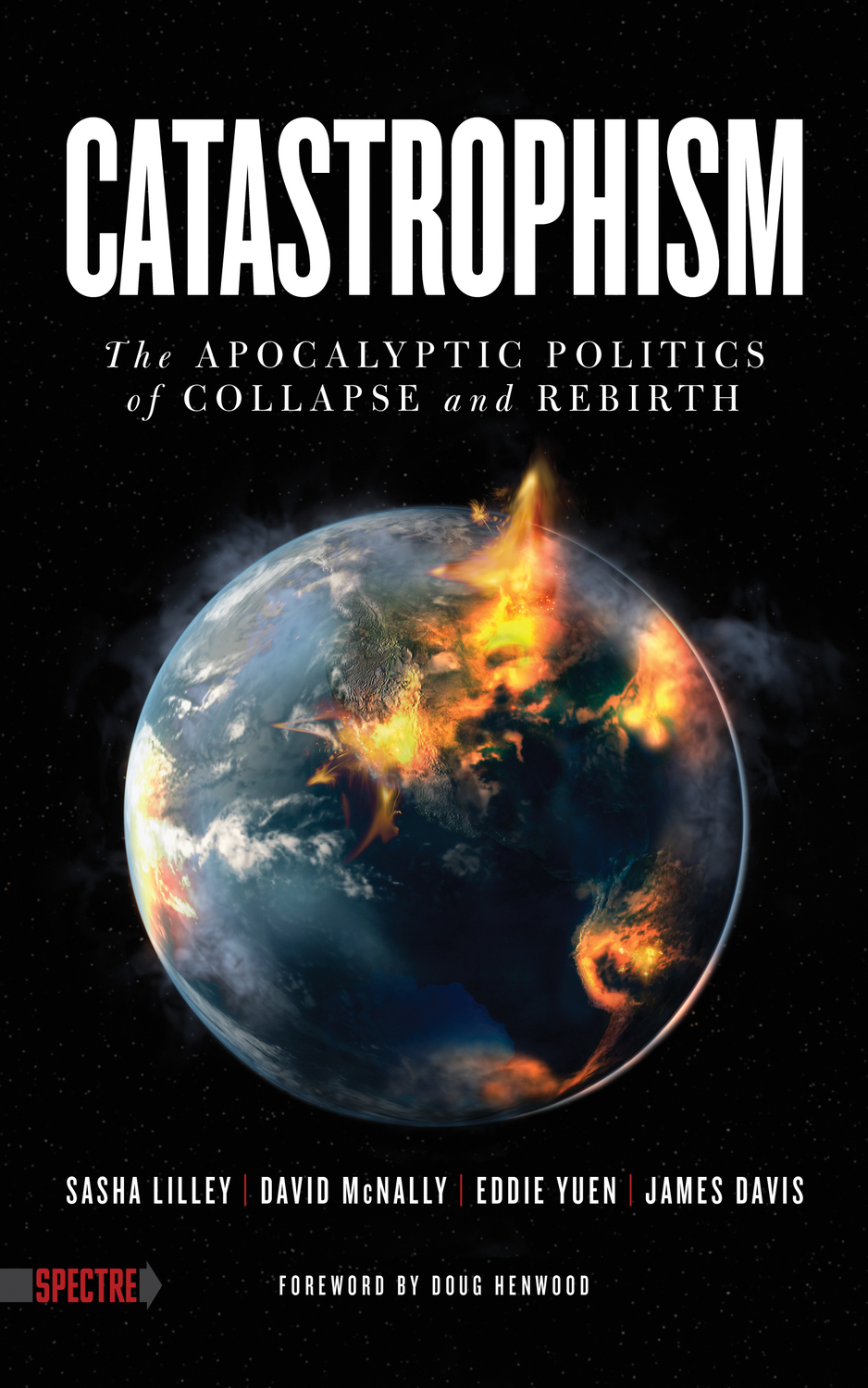
Catastrophism Amid a global zeitgeist of impending catastrophe, this book explores the culture of fear so prevalent in today's politics, economic climate, and religious extremism. The authors of this collection argue that the lens of catastrophe through which so many of today's issues are examined distorts understanding of the dynamics at the heart of numerous problems, such as global warming, ultimately halting progress and transformation. Arguing that catastrophic thinking results in paralysis or reactionary politics, the authors posit that the myths of 2012 have negative affects across the political spectrum and urge activists not to give up their beliefs and instead focus on working on issues now instead of waiting until society has ended and needs to be rebuilt. POLITICAL SCIENCE,Political Ideologies,General

Cosmopolitanism A short, authoritative and critical guide to a much-debated concept in social science. From the history of cosmopolitanism to the "cosmopolitan turn" in contemporary society, this book is a must for students attempting to understand human interaction in a postmodern world. POLITICAL SCIENCE,Political Ideologies,General

British Politics and the Environment Britain has an immense range of environmental law and the reputation for largely ignoring it. John McCormick describes the fascinating story of the political growth of that law, and the pressures, the compromises, the parliamentary and civil service opportunism that allowed the edifice to grow over the greater part of a century.He tells the story of the absolute change in political climate over the last ten years and deciphers the nature of Thatcher's ''conversion'' to greenery. He explains why everyone who cared about the environment became embattled and, above all, how the old methods of sensible compromise were banished, probably for ever, not least because of the government's obsession with secrecy.What, then, are the new political means of compelling change on a reluctant parliament? Everything is at stake from welfare to water, from forests to fishing. Where are we now? What are the likely pressures, both internal and from Europe and the rest of the world, to make Britain pass more environmentally sound laws and, perhaps more importantly, to observe them? McCormick provides a gripping picture of the central issues, of the system and of the battleground.Originally published in 1991 POLITICAL SCIENCE,Political Ideologies,General
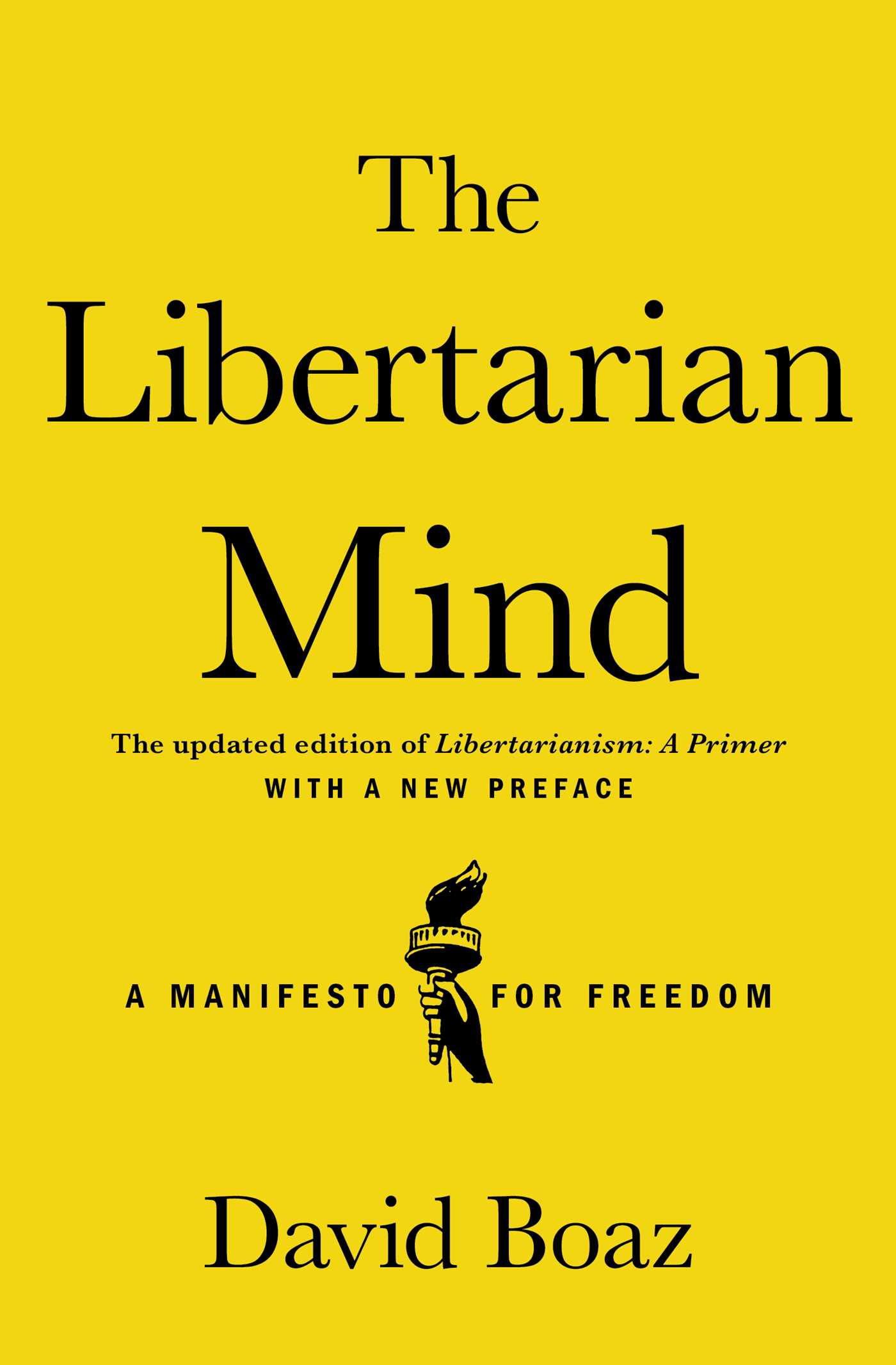
The Libertarian Mind A revised, updated, and retitled edition of David Boaz’s classic book Libertarianism: A Primer, which was praised as uniting “history, philosophy, economics and law—spiced with just the right anecdotes—to bring alive a vital tradition of American political thought that deserves to be honored today†(Richard A. Epstein, University of Chicago). Libertarianism—the philosophy of personal and economic freedom—has deep roots in Western civilization and in American history, and it’s growing stronger. Two long wars, chronic deficits, the financial crisis, the costly drug war, the campaigns of Ron Paul and Rand Paul, the growth of executive power under Presidents Bush and Obama, and the revelations about NSA abuses have pushed millions more Americans in a libertarian direction. Libertarianism: A Primer, by David Boaz, the longtime executive vice president of the Cato Institute, continues to be the best available guide to the history, ideas, and growth of this increasingly important political movement—and now it has been updated throughout and with a new title: The Libertarian Mind. Boaz has updated the book with new information on the threat of government surveillance; the policies that led up to and stemmed from the 2008 financial crisis; corruption in Washington; and the unsustainable welfare state. The Libertarian Mind is the ultimate resource for the current, burgeoning libertarian movement. POLITICAL SCIENCE,Political Ideologies,General

Dictatorship Now available in English for the first time, Dictatorship is Carl Schmitt’s most scholarly book and arguably a paradigm for his entire work. Written shortly after the Russian Revolution and the First World War, Schmitt analyses the problem of the state of emergency and the power of the Reichspräsident in declaring it. Dictatorship, Schmitt argues, is a necessary legal institution in constitutional law and has been wrongly portrayed as just the arbitrary rule of a so-called dictator. Dictatorship is an essential book for understanding the work of Carl Schmitt and a major contribution to the modern theory of a democratic, constitutional state. And despite being written in the early part of the twentieth century, it speaks with remarkable prescience to our contemporary political concerns. POLITICAL SCIENCE,Political Ideologies,General
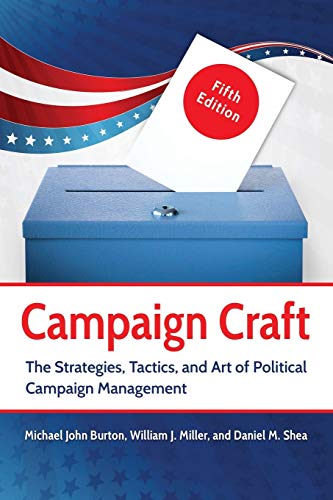
Campaign Craft Political campaigning reinvents itself at a furious pace. This highly respected text recounts the evolution of modern campaign management and shares strategies and tactics common to American elections. Informed by the practical political experience of three scholarly authors, the book weaves important academic perspectives with insights garnered from close observation of electoral practice. The fifth edition lays out the foundations of modern campaign management, going on to explore critical steps in running a "new style" campaign. Using fresh stories and recent research, the book follows American electioneering from the planning stages through Election Day and concludes with a view to the future of political campaigning. Critical updates examine the Tea Party movement, new political technologies, advances (and challenges) in opinion polling and field experimentation, and increasing polarization within the American electorate. New material includes an exploration of the Super PACs and non-candidate campaigns that are changing the strategic context of American elections. POLITICAL SCIENCE,Political Ideologies,General
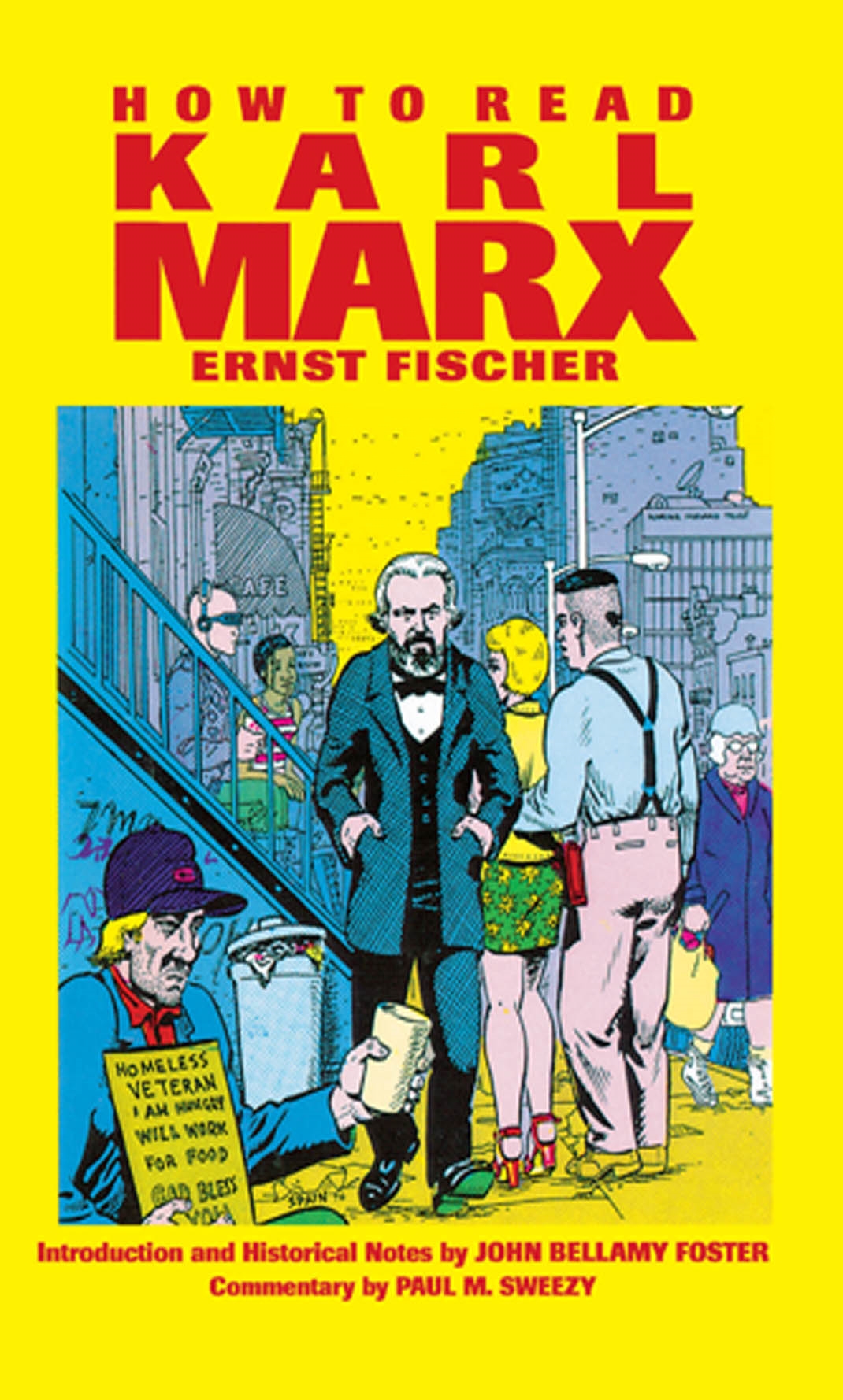
How To Read Karl Marx A brief, clear, and faithful exposition of Marx's major premises, with particular attention to historical context. POLITICAL SCIENCE,Political Ideologies,General
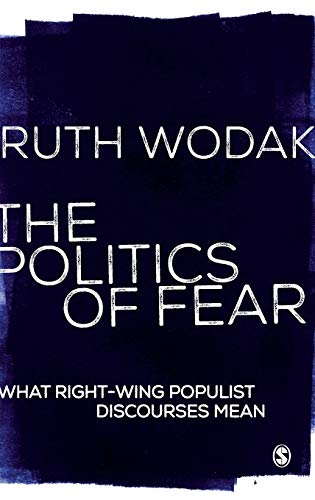
The Politics of Fear Winner of the Austrian Book Prize for the 2016 German translation, in the category of Humanities and Social Sciences. A cutting-edge exploration of the power and prevalence of contemporary right-wing populist discourse. POLITICAL SCIENCE,Political Ideologies,General

If You Can Keep It #1 New York Times bestselling author Eric Metaxas delivers an extraordinary book that is part history and part rousing call to arms, steeped in a critical analysis of our founding fathers' original intentions for America. In 1787, when the Constitution was drafted, a woman asked Ben Franklin what the founders had given the American people. "A republic," he shot back, "if you can keep it." More than two centuries later, Metaxas examines what that means and how we are doing on that score. If You Can Keep It is at once a thrilling review of America's uniqueness—including our role as a "nation of nations"—and a chilling reminder that America's greatness cannot continue unless we embrace our own crucial role in living out what the founders entrusted to us. Metaxas explains that America is not a nation bounded by ethnic identity or geography, but rather by a radical and unprecedented idea, based on liberty and freedom for all. He cautions us that it's nearly past time we reconnect to that idea, or we may lose the very foundation of what made us exceptional in the first place. POLITICAL SCIENCE,Political Ideologies,General
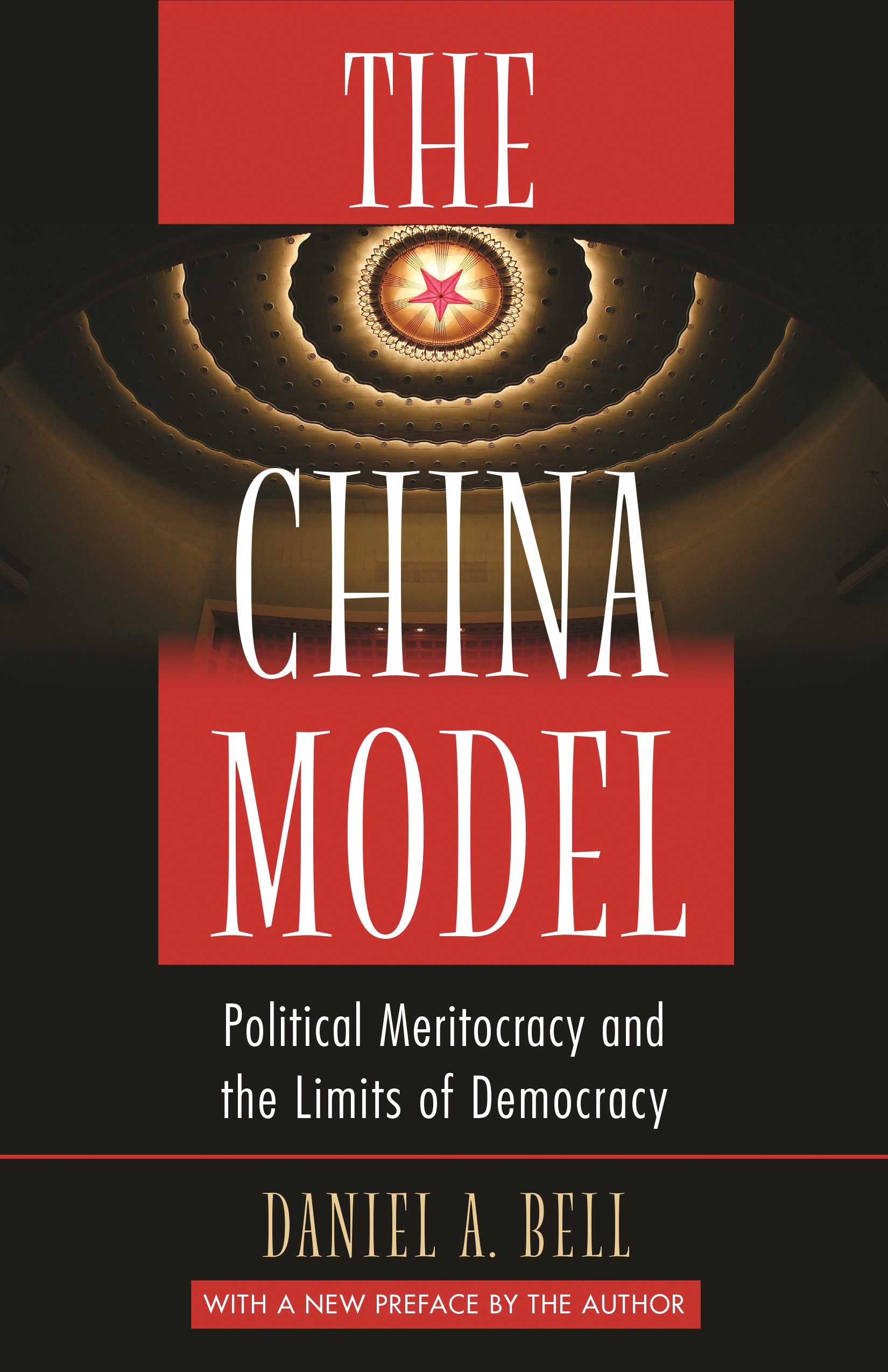
The China Model How China's political model could prove to be a viable alternative to Western democracy Westerners tend to divide the political world into "good" democracies and “bad†authoritarian regimes. But the Chinese political model does not fit neatly in either category. Over the past three decades, China has evolved a political system that can best be described as “political meritocracy.†The China Model seeks to understand the ideals and the reality of this unique political system. How do the ideals of political meritocracy set the standard for evaluating political progress (and regress) in China? How can China avoid the disadvantages of political meritocracy? And how can political meritocracy best be combined with democracy? Daniel Bell answers these questions and more. Opening with a critique of “one person, one vote†as a way of choosing top leaders, Bell argues that Chinese-style political meritocracy can help to remedy the key flaws of electoral democracy. He discusses the advantages and pitfalls of political meritocracy, distinguishes between different ways of combining meritocracy and democracy, and argues that China has evolved a model of democratic meritocracy that is morally desirable and politically stable. Bell summarizes and evaluates the “China modelâ€â€”meritocracy at the top, experimentation in the middle, and democracy at the bottom—and its implications for the rest of the world. A timely and original book that will stir up interest and debate, The China Model looks at a political system that not only has had a long history in China, but could prove to be the most important political development of the twenty-first century. POLITICAL SCIENCE,Political Ideologies,General

The Protestant Work Ethic and the Spirit of Capitalism In The Protestant Ethic, Max Weber opposes the Marxist concept of dialectical materialism and relates the rise of the capitalist economy to the Calvinist belief in the moral value of hard work and the fulfillment of one's worldly duties. Based on the original 1905 edition, this volume includes, along with Weber's treatise, an illuminating introduction, a wealth of explanatory notes, and exemplary responses and remarks-both from Weber and his critics-sparked by publication of The Protestant Ethic and the Spirit of Capitalism. POLITICAL SCIENCE,Political Ideologies,General
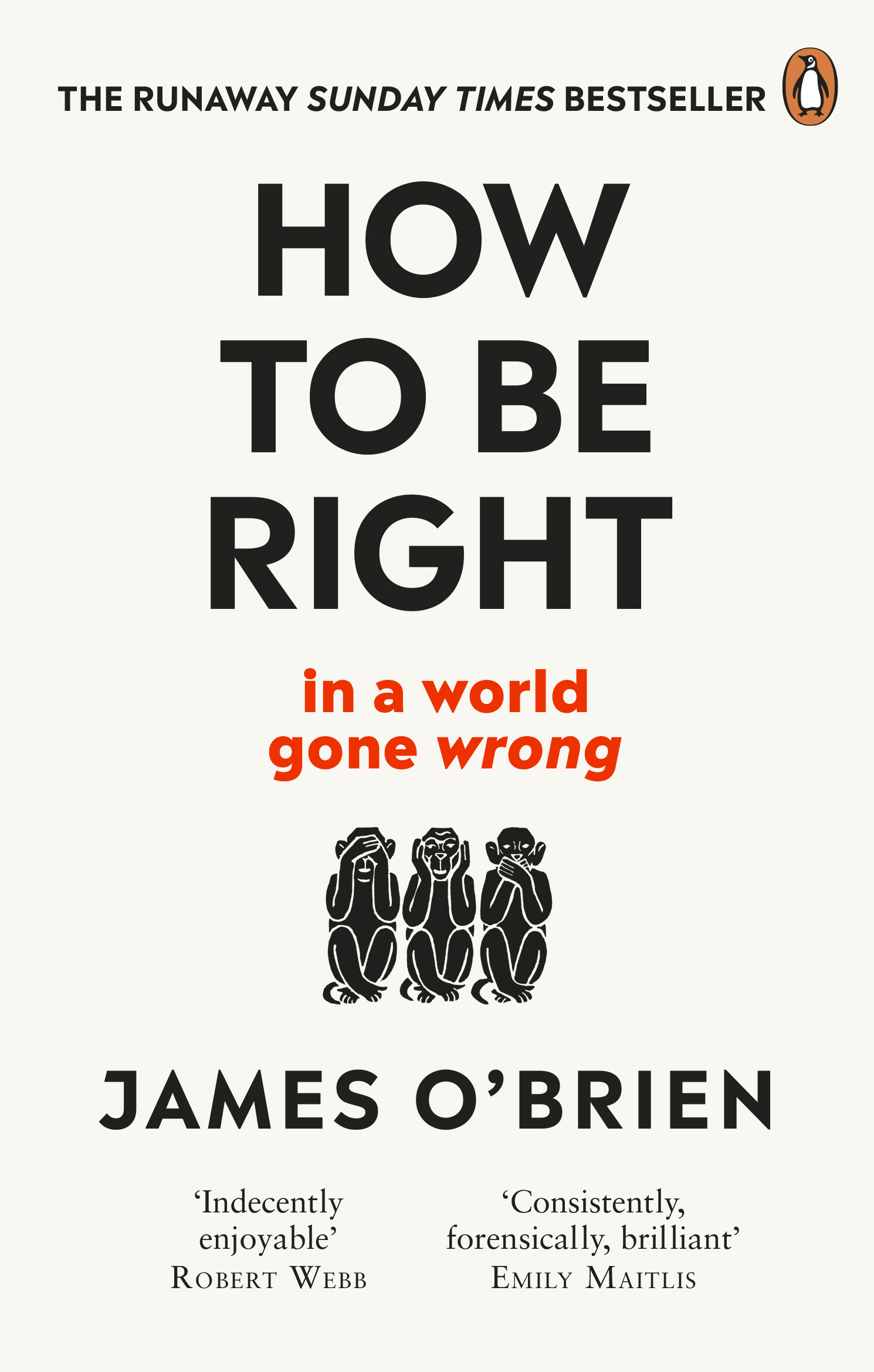
How To Be Right The voice of reason in a world that won’t shut up. The Sunday Times Bestseller Winner of the Parliamentary Book Awards Every day, James O’Brien listens to people blaming hard-working immigrants for stealing their jobs while scrounging benefits, and pointing their fingers at the EU and feminists for destroying Britain. But what makes James’s daily LBC show such essential listening – and has made James a standout social media star – is the incisive way he punctures their assumptions and dismantles their arguments live on air, every single morning. In the bestselling How To Be Right, James provides a hilarious and invigorating guide to talking to people with unchallenged opinions. With chapters on every lightning-rod issue, James shows how people have been fooled into thinking the way they do, and in each case outlines the key questions to ask to reveal fallacies, inconsistencies and double standards. If you ever get cornered by ardent Brexiteers, Daily Mail disciples or corporate cronies, this book is your conversation survival guide. POLITICAL SCIENCE,Political Ideologies,General
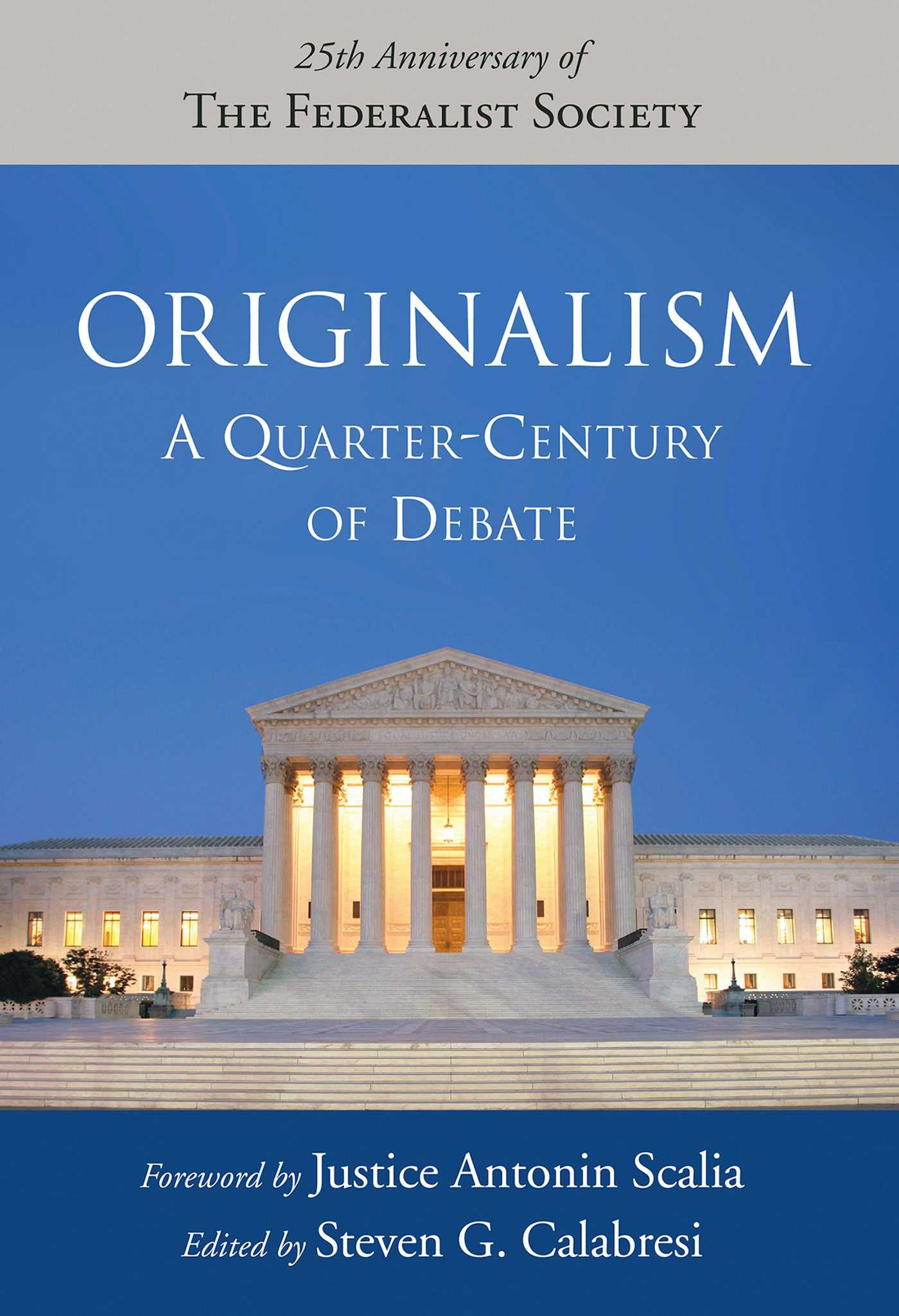
Originalism What did the Constitution mean at the time it was adopted? How should we interpret today the words used by the Founding Fathers? In ORIGINALISM: A QUARTER-CENTURY OF DEBATE, these questions are explained and dissected by the very people who continue to shape the legal structure of our country.This is a lively and fascinating discussion of an issue that has occupied the greatest legal minds in America, and one that continues to elicit strong reactions from both those who support and those who oppose the rule of law. Steven G. Calabresi, co-founder of the Federalist Society and professor of law at Northwestern University School of Law, has compiled an impressive collection of speeches, panel discussions, and debates from some of the greatest and most prominent legal experts of the last twenty-five years. POLITICAL SCIENCE,Political Ideologies,General
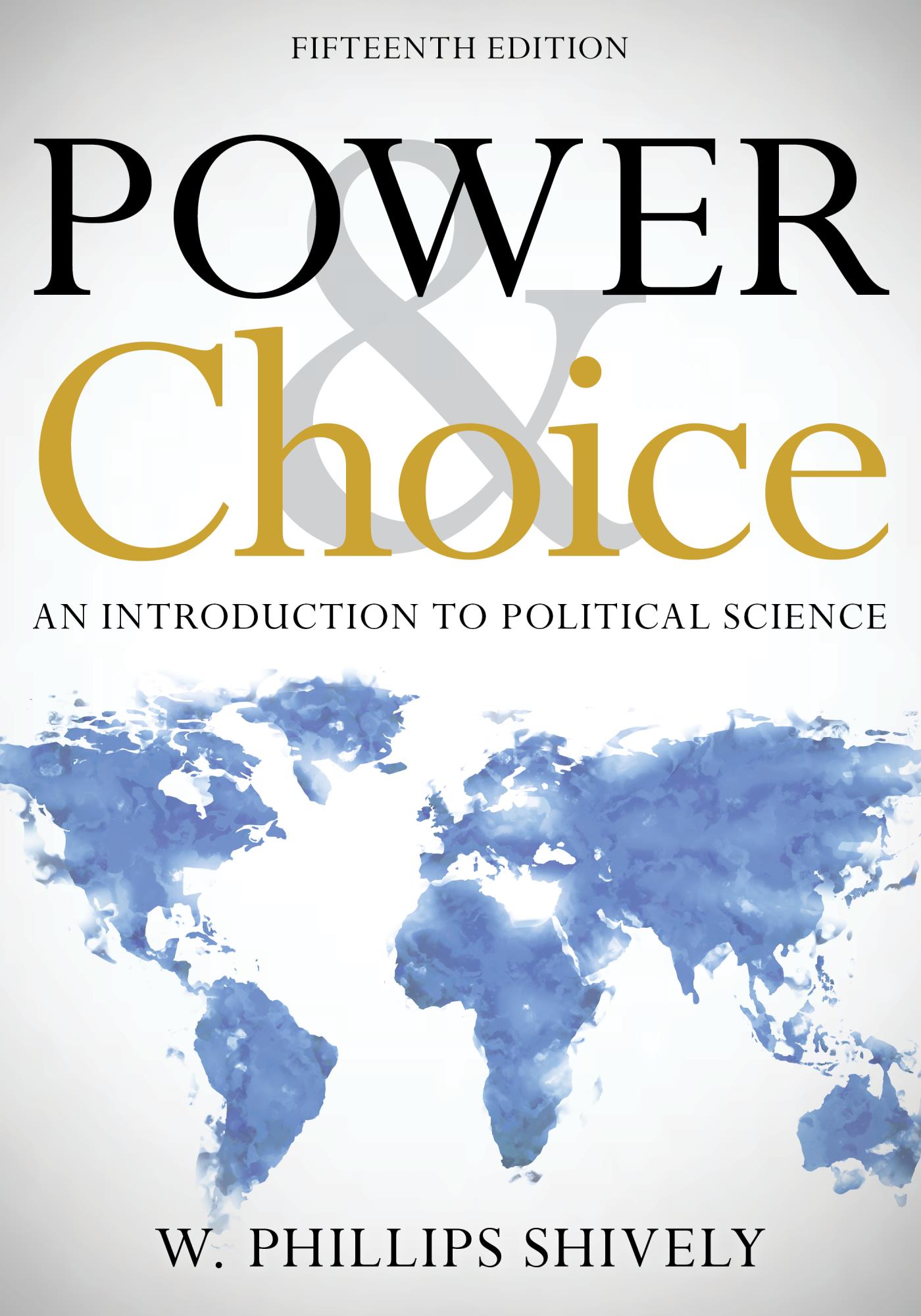
Power & Choice Power & Choice provides a general, comparative introduction to the major concepts and themes of political science. The author’s goal when writing the book was a text that is conceptually alive and that engages students with concrete examples of analysis without losing them “in a clutter of definitional minutiae." POLITICAL SCIENCE,Political Ideologies,General
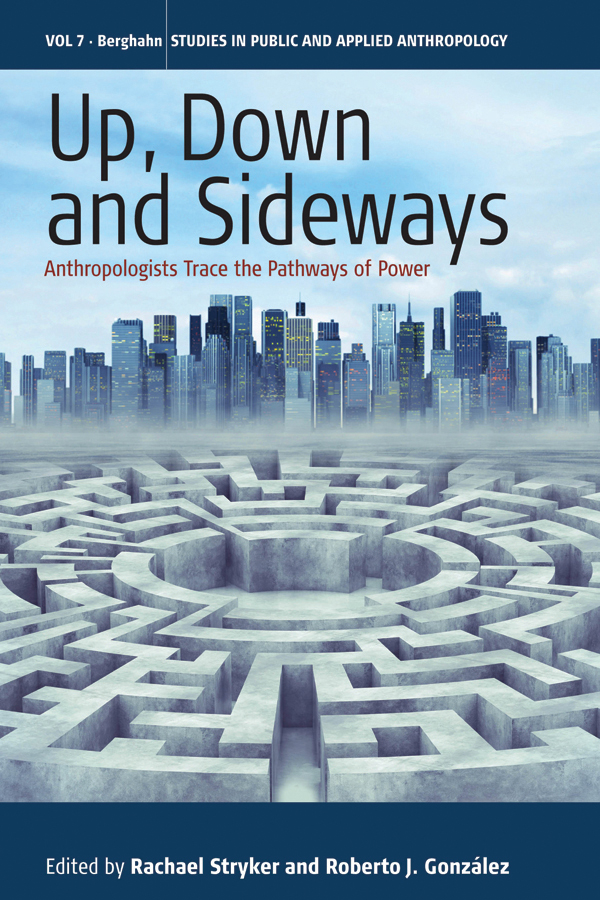
Up, Down, and Sideways Using a “vertical slice†approach, anthropologists critically analyze the relationship between undemocratic uses and abuses of power and the survival of the human species. The contributors scrutinize modern institutions in a variety of regions—from Russia and Mexico to South Korea and the U.S. Up, Down, and Sideways is an ethnographic examination of such phenomena as debtculture, global financial crises, food insecurity, indigenous land and resource appropriation, the mismanagement of health care, andcorporate surrogacy within family life. With a preface by Laura Nader, this isessential reading for anyone seeking solid theories and concrete methods to inform activist scholarship. POLITICAL SCIENCE,Political Ideologies,General

Making Ubumwe Since the end of the Rwandan genocide, the new political elite has been challenged with building a unified nation. Reaching beyond the better-studied topics of post-conflict justice and memory, the book investigates the project of civic education, the upsurge of state-led neo-traditional institutions and activities, and the use of camps and retreats shape the “ideal†Rwandan citizen. Rwanda’s ingando camps offer unique insights into the uses of dislocation and liminality in an attempt to anchor identities and desired political roles, to practically orient and symbolically place individuals in the new Rwandan order, and, ultimately, to create additional platforms for the reproduction of political power itself. POLITICAL SCIENCE,Political Ideologies,General
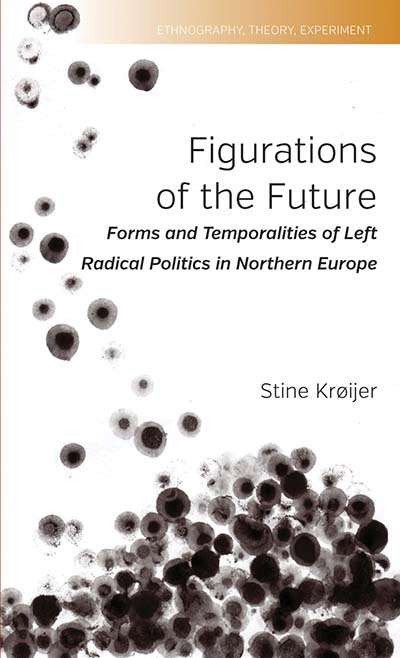
Figurations of the Future Built around key events, from the eviction of a self-managed social centre in Copenhagen in 2007 to the Climate Summit protests in 2009, this book contributes to anthropological literature on contemporary Euro-American politics foreshadowing recent waves of public dissent. Stine Krøijer explores political forms among left radical and anarchist activists in Northern Europe focusing on how forms of action engender time. Drawing on anthropological literature from both Scandinavia and the Amazon, this ethnography recasts theoretical concerns about body politics, political intentionality, aesthetics, and time. POLITICAL SCIENCE,Political Ideologies,General
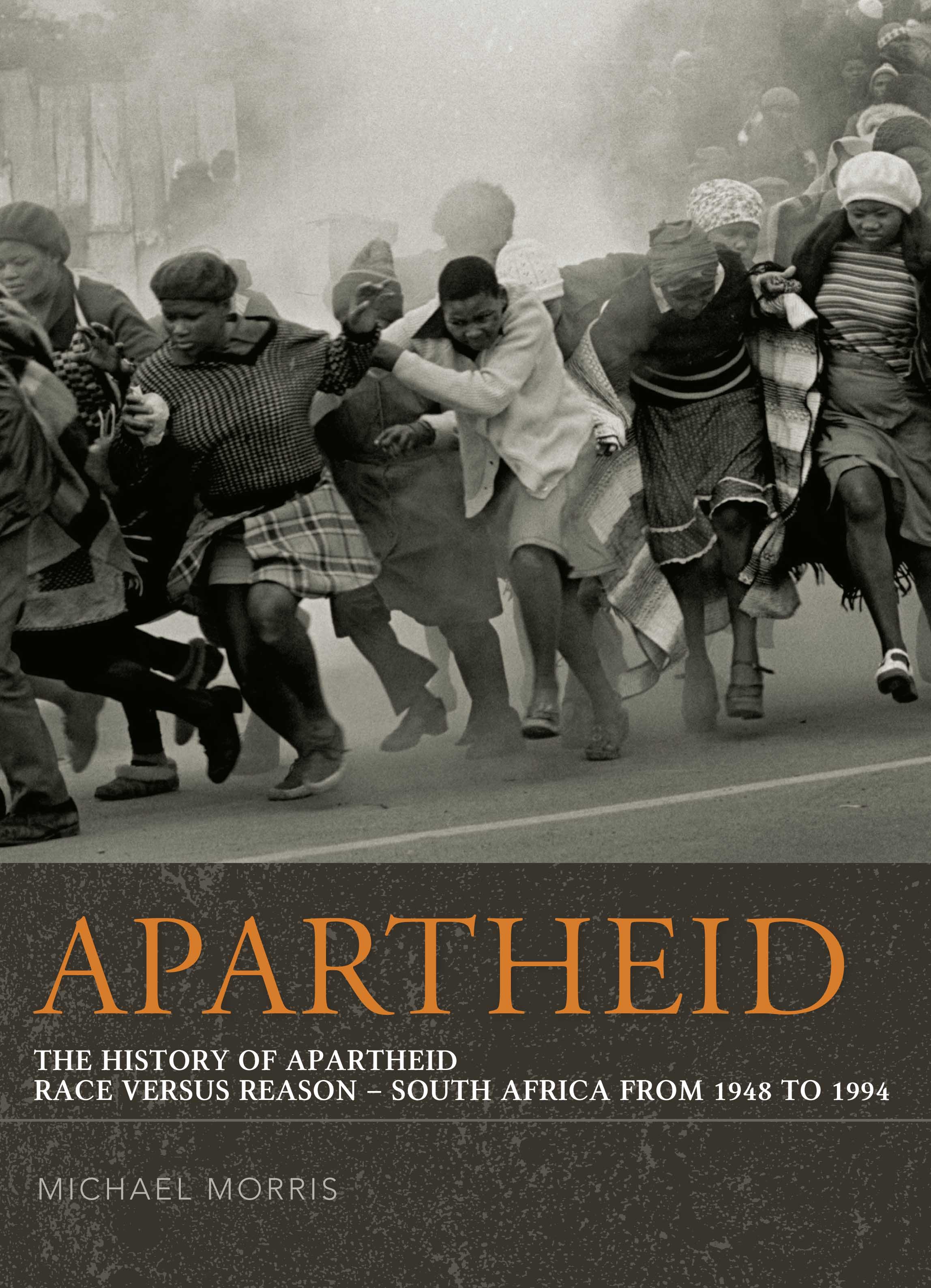
Apartheid The one thing that looms largest in South Africa’s future is South Africa’s past – most especially the nearly five decades of division and conflict at the heart of one of the twentieth century’s most infamous social experiments. Apartheid, An Illustrated History is a portrait of the defining experience of modern South Africa’s transition from colonial state to democracy. What began in May 1948 as a vague, grimly ambitious project to interrupt history and engineer white supremacy at the expense of the country’s black majority spawned forty-six years of repressive authoritarianism and bitter resistance which claimed the lives of thousands and pushed the country to the brink of civil conflict. A provocative postscript examines apartheid’s stubborn afterlife in the years since 1994, suggesting that the optimism and democratic vitality of the constitutional state hinge on South Africans avoiding simplistic views of the past that might lend themselves to demagoguery. For all its catastrophic and lingering effects, the book concludes, apartheid was disarmed, ultimately, by the society’s much longer history of inseparability. POLITICAL SCIENCE,Political Ideologies,General

Political Ideologies and the Democratic Ideal Political Ideologies and the Democratic Ideal analyzes political ideologies to help readers understand individual ideologies, and the concept of ideology, from a political science perspective. This best-selling title promotes open-mindedness and develops critical thinking skills. It covers a wide variety of political ideologies from the traditional liberalism and conservatism to recent developments in liberation politics, the emergence of the Alt-Right, and environmental politics. NEW TO THIS EDITION Focus on the recent rise of populism and an "illiberal democracy" and how this poses a real challenge to the pillars of Western Liberal democracy; A look at early Conservatives and the idea of "natural aristocracy" with focus on the thoughts of Edmund Burke; A new discussion on whether Donald Trump is really a conservative, and if so, to what extent this is true; An expanded look at Stalinism and the apparent rebirth of "Mao Zedong thought" in China through "Xi Jinping thought"; A more in-depth look at the rise of Hitler and the Nazi Party and how "myth" was crucial to legitimizing both the man and the party; New section on the history of American Fascism, from its origins to the recent emergence of the "Alt-Right"; Expansion of the discussion around the recent protest movements Black Lives Matter, and #MeToo, along with the repercussions of these movements; Discussion on the obstacles facing transgender people implemented in recent years, including the bathroom laws and the ban from US military service; Account of how Donald Trump has galvanized the environmental movement like never before, through his ardent anti-environment policies and appointments; In-depth look at how the effects of climate change are increasingly turning people into "environmental migrants" and how the presence of these people has fueled far-right movements across Europe and the US; Additional photos throughout; An updated, author-written Instructor’s Manual and Test Bank. POLITICAL SCIENCE,Political Ideologies,General
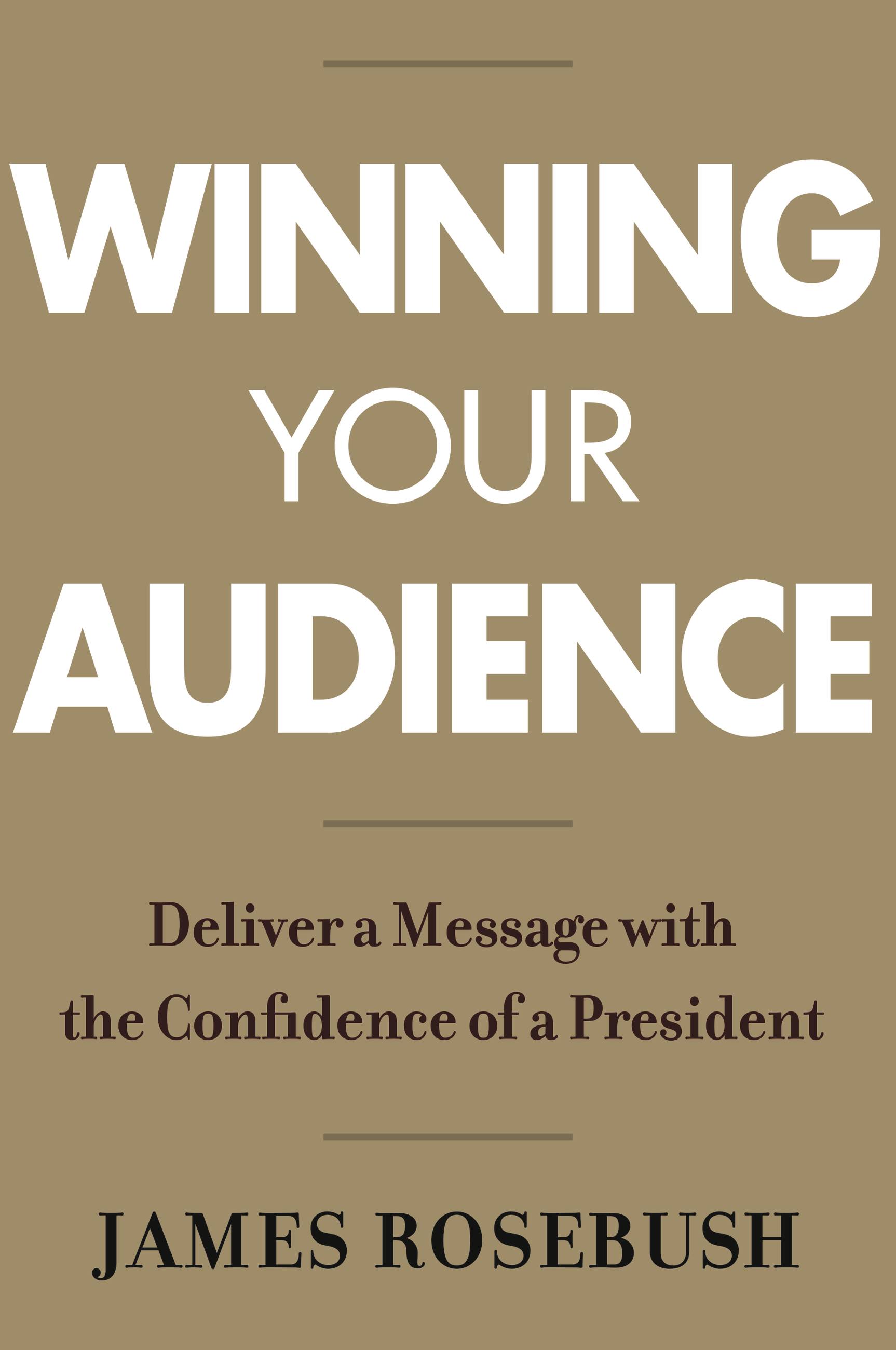
Winning Your Audience President Ronald Reagan taught James Rosebush to be an impactful speaker. Now he's going to teach you. Public speaking isn't easy. Just ask anyone who's ever blown a sales pitch, failed a class, or fumbled their way through a presentation because they froze up or couldn't find the right words. No wonder more than 75 percent of people in the United States suffer from Glossophobia, the fear of speaking in front of crowds. Luckily, public speaking isn't some innate ability. It's a skill. And given the right amount of time, energy, and perseverance, anyone can learn how it's done. In Winning Your Audience, James Rosebush draws on several decades of experience working with presidents, politicians, and business leaders to write his own manual for delivering a message with confidence. He looks back on the lessons he learned travelling the world with President Ronald Reagan, whom he served under for five years in the White House, and lays out the keys to "the Reagan speech template": Question, Inform, Inspire, Ask. Rosebush also studies some of the great political orators of our time. Vital lessons from the likes of Winston Churchill, Abraham Lincoln, Frederick Douglass, and President Donald Trump are distilled down to a few simple rules. Among them are: · Be authentic · Know yourself · Practice and rehearse...and then do it again · Don't care what your mother thinks of you No matter what kind of speeches, toasts, or presentations you have to give, this book can help. Use it like a textbook. Write in the margins. Tear out pages. Winning Your Audience can make even the most timid speakers among us into a genuine leaders. Read it now and learn how to win your audience. POLITICAL SCIENCE,Political Ideologies,General
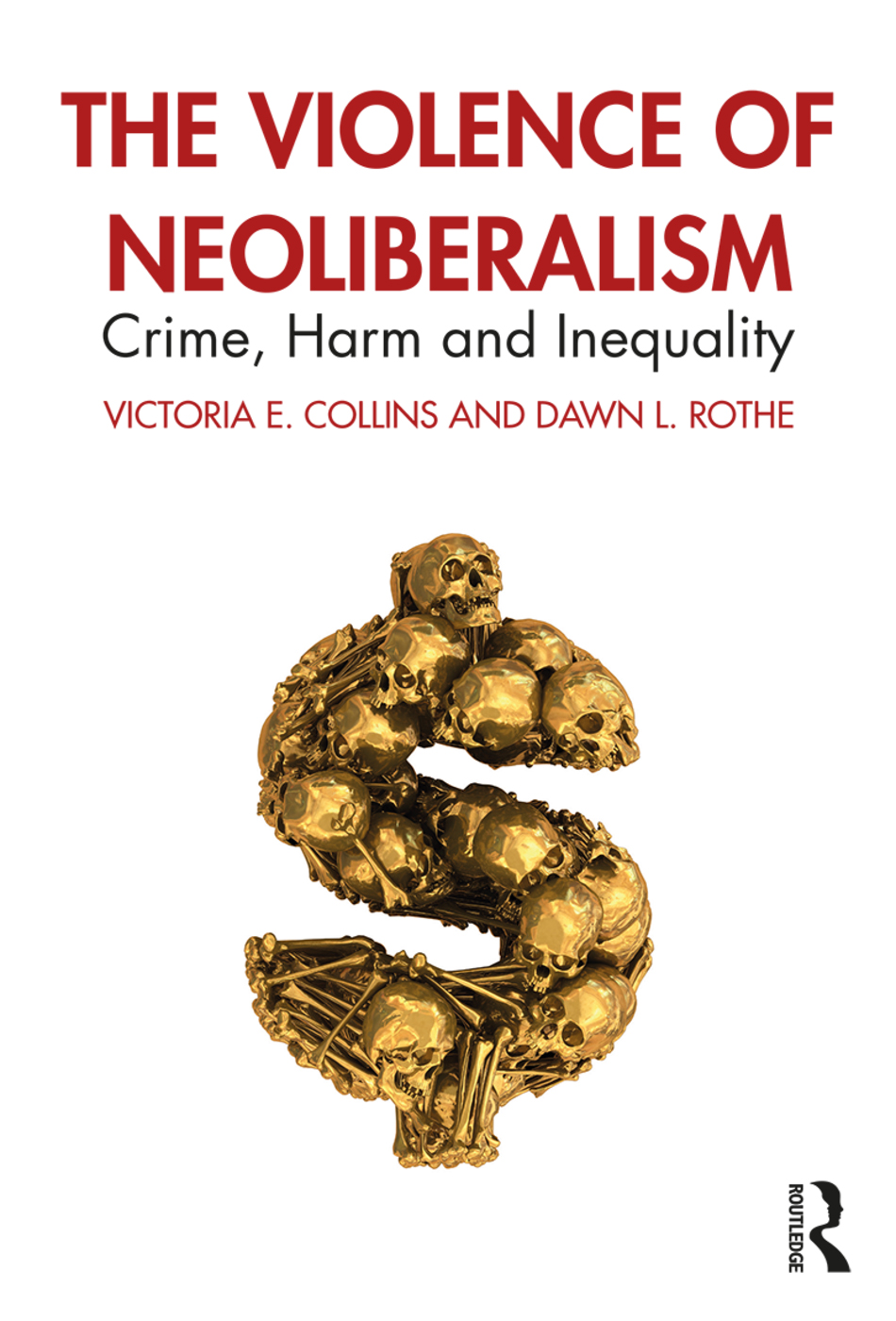
The Violence of Neoliberalism This book examines the impact of neoliberalism on society, bringing to the forefront a discussion of violence and harm, the inherent inequalities of neoliberalism and the ways in which our everyday lives in the Global North reproduce and facilitate this violence and harm. Drawing on a range of contemporary topics such as state violence, the carceral state, patriarchy, toxic masculinity, death, sports and entertainment, this book unmasks the banal forms of violence and harm that are a routine part of life that usurp, commodify and consume to reify the existing status quo of harm and inequality. It aims to defamiliarize routine forms of violence and inequality, thereby highlighting our own participation in its perpetuation, though consumerism and the consumption of neoliberal dogma. It is essential reading for students across criminology, sociology and political philosophy, particularly those engaged with crimes of the powerful, state crime and social harm. POLITICAL SCIENCE,Political Ideologies,General

Understanding Dogmas and Dreams Nancy Love’s concise yet complete volume aims to inform students of their choices among political values. By exploring the assumptions of various ideologies and comparing their positions, students begin to understand political alternatives to be able to choose among them—in essence, they learn to think democratically. Offering historical and analytic context for the selections in her companion reader, Dogmas and Dreams, Love challenges students to consider the various ways ideological frameworks shape political actions. Reframing her approach in this second edition, Love examines how traditional left/right ideologies—liberalism and conservatism, socialism and fascism—are shifting to adapt to new political realities in an ever turbulent, post-9/11 world. She also discusses why alternative ideologies—feminism, environmentalism, fundamentalism, and globalization—may better convey our global political future. While pushing the boundaries of the left/right political spectrum, she looks at how grassroots social movements offer alternative ways to view ideological differences, from cluster-concepts to micro-discourses, and even a planetary galaxy. Expanded coverage includes: a new chapter on nationalism and globalization, which examines the work of Samuel Huntington, Kenichi Ohmae, Benjamin Barber, and many more, to explore fundamentalism in Islamic politics increased coverage of global environmental politics, including Shiva’s Stolen Harvest and Kelly’s Thinking Green, examining the relationships between developed and developing countries fresh material on socialist politics post-1989 and the rise of neo-fascist movements in the United States and Europe, including analysis of Hayden and Flacks’ “The Port Huron Statement at 40†and Bob Moser’s “The Age of Rage†an updated feminism chapter that considers the impact of third-wave, post-colonial, and so-called “power†feminists and incorporates new analysis of Wollstonecraft’s A Vindication of the Rights of Woman and Mohanty’s Under Western Eyes Revisited A thinking person’s package… Nancy Love wrote Understanding Dogmas and Dreams with her edited collection in mind—the two work together as a seamless package and give students great value for their money. Order the two books shrink-wrapped at significant savings. Please specify ISBN 0-87289-287-5. For the full table of contents of Love’s reader, Dogmas and Dreams, click here. POLITICAL SCIENCE,Political Ideologies,General
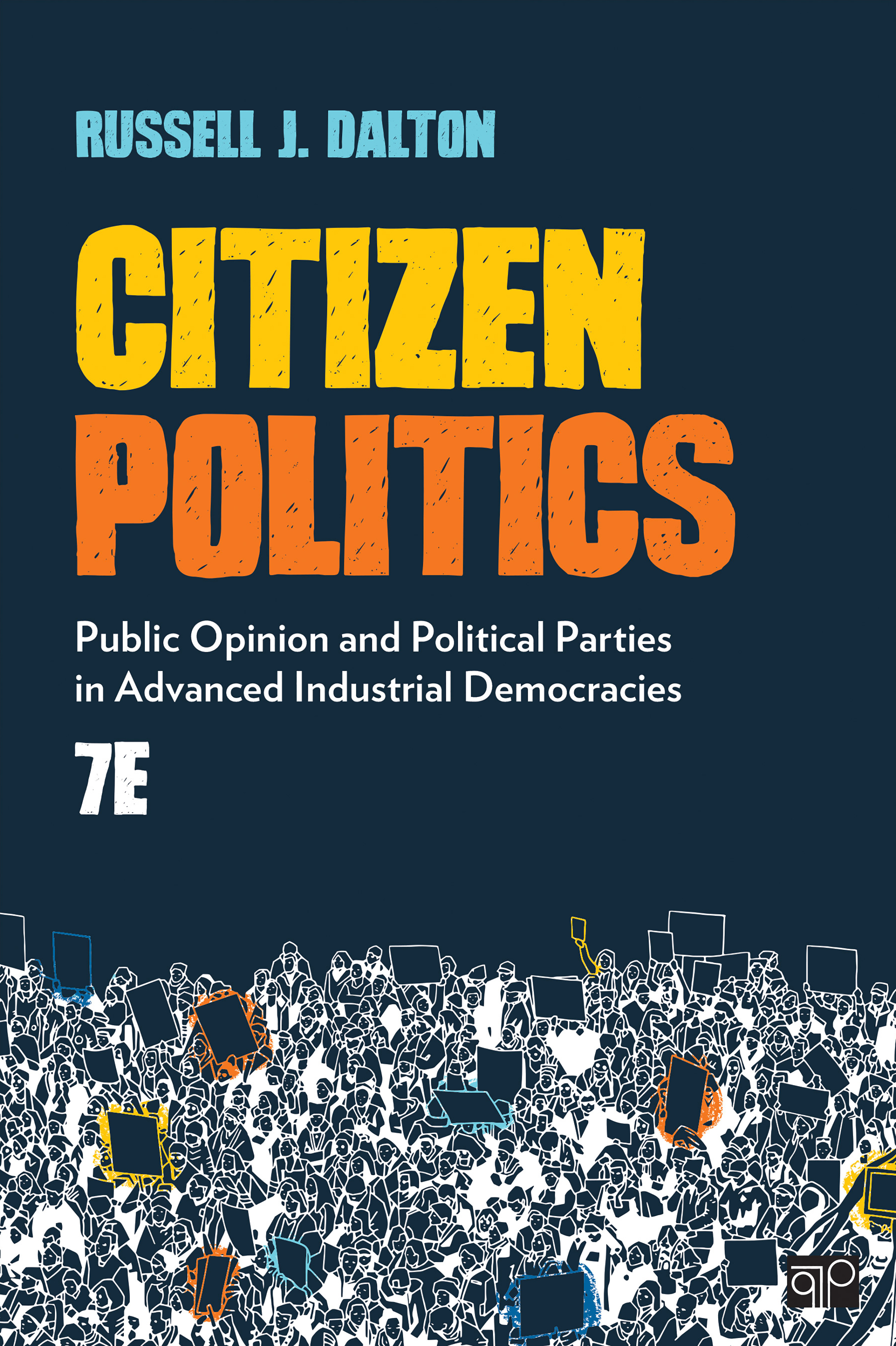
Citizen Politics Now, more than ever, people drive the democratic process. What people think of their government and its leaders, how (or whether) they vote, and what they do or say about a host of political issues greatly affect the further strengthening or erosion of democracy and democratic ideals. This fully updated, shorter Seventh Edition of Citizen Politics continues to offer the only truly comparative study of political attitudes and behavior in the United States, Great Britain, France, and Germany. In addition to its comprehensive, thematic examination of political values, political activity, voting, and public images of government within a cross-national context, the updated edition of this bestseller explores how cultural issues, populism, Trump and far right parties are reshaping politics in contemporary democracies. All chapters have been updated with the latest research and empirical evidence. Further, Dalton includes recent research on citizens’ political behavior in USA, Britain, France, and Germany, as well as new evidence from national election studies in USA 2016, Britain 2017, France 2017, and Germany 2017. POLITICAL SCIENCE,Political Ideologies,General
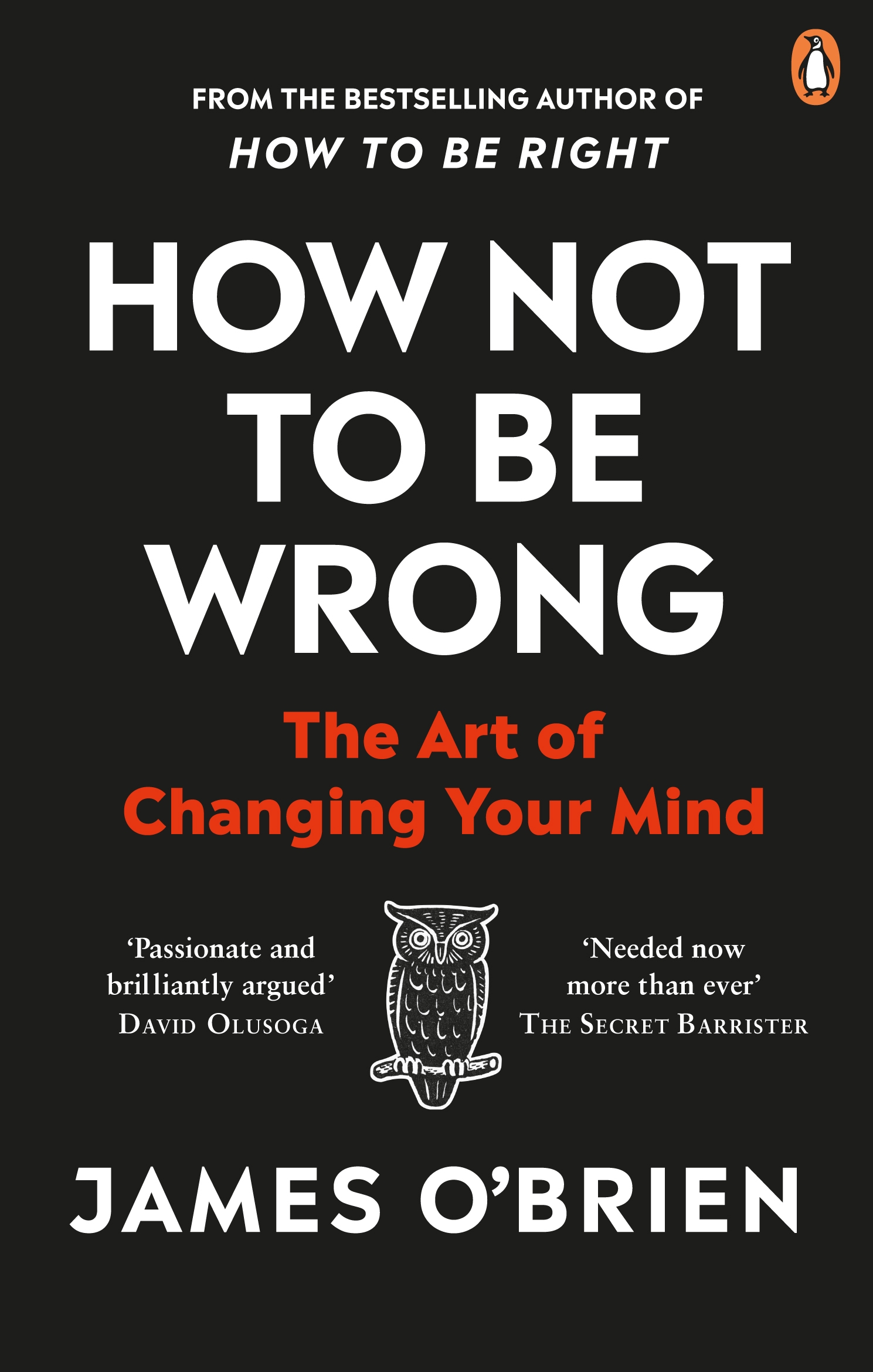
How Not To Be Wrong 'Simply Brilliant' THE SECRET BARRISTER 'Passionate and brilliantly argued' DAVID OLUSOGA 'An admirably personal guide' MARINA HYDE 'Smart, analytical, self-aware and important' ALASTAIR CAMPBELL THE INTIMATE, REVEALING NEW BOOK FROM THE AUTHOR OF THE BESTSELLING, PRIZE-WINNING HOW TO BE RIGHT There's no point having a mind if you're not willing to change it James O'Brien has built well over a million loyal listeners to his radio show by dissecting the opinions of callers live on air, every day. But winning the argument doesn't necessarily mean you're right. In this deeply personal book, James turns the mirror on himself to reveal what he has changed his mind about and why, and explores how examining and changing our own views is our new civic duty in a world of outrage, disagreement and echo chambers. He writes candidly about the stiff upper lip attitudes and toxic masculinity that coloured his childhood, and the therapy and personal growth that have led him question his assumptions and explore new perspectives. Laying open his personal views on everything from racial prejudice to emotional vulnerability, from fat-shaming to tattoos, he then delves into the real reasons -- often irrational or unconscious -- he holds them. Unflinchingly honest, revealing and funny, How Not to Be Wrong is a tonic for a world more divided than ever and a personal manifesto for a better way of thinking and living. Because after all, if we can't change our own minds we'll never really be able to change anyone else's. POLITICAL SCIENCE,Political Ideologies,General
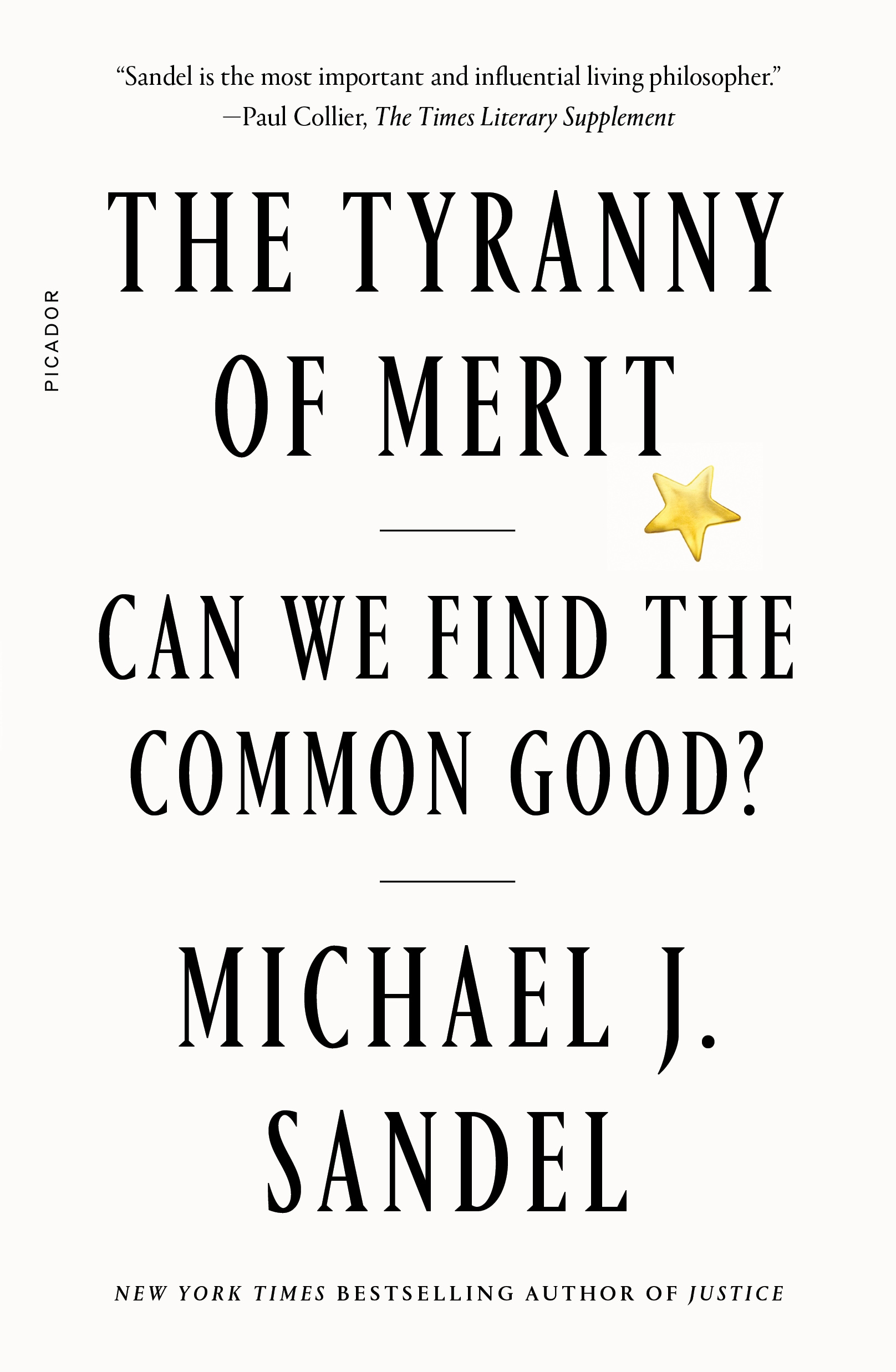
The Tyranny of Merit The world-renowned philosopher and author of the bestselling Justice explores the central question of our time: What has become of the common good? These are dangerous times for democracy. We live in an age of winners and losers, where the odds are stacked in favor of the already fortunate. Stalled social mobility and entrenched inequality give the lie to the American credo that "you can make it if you try". The consequence is a brew of anger and frustration that has fueled populist protest and extreme polarization, and led to deep distrust of both government and our fellow citizens--leaving us morally unprepared to face the profound challenges of our time. World-renowned philosopher Michael J. Sandel argues that to overcome the crises that are upending our world, we must rethink the attitudes toward success and failure that have accompanied globalization and rising inequality. Sandel shows the hubris a meritocracy generates among the winners and the harsh judgement it imposes on those left behind, and traces the dire consequences across a wide swath of American life. He offers an alternative way of thinking about success--more attentive to the role of luck in human affairs, more conducive to an ethic of humility and solidarity, and more affirming of the dignity of work. The Tyranny of Merit points us toward a hopeful vision of a new politics of the common good. POLITICAL SCIENCE,Political Ideologies,General
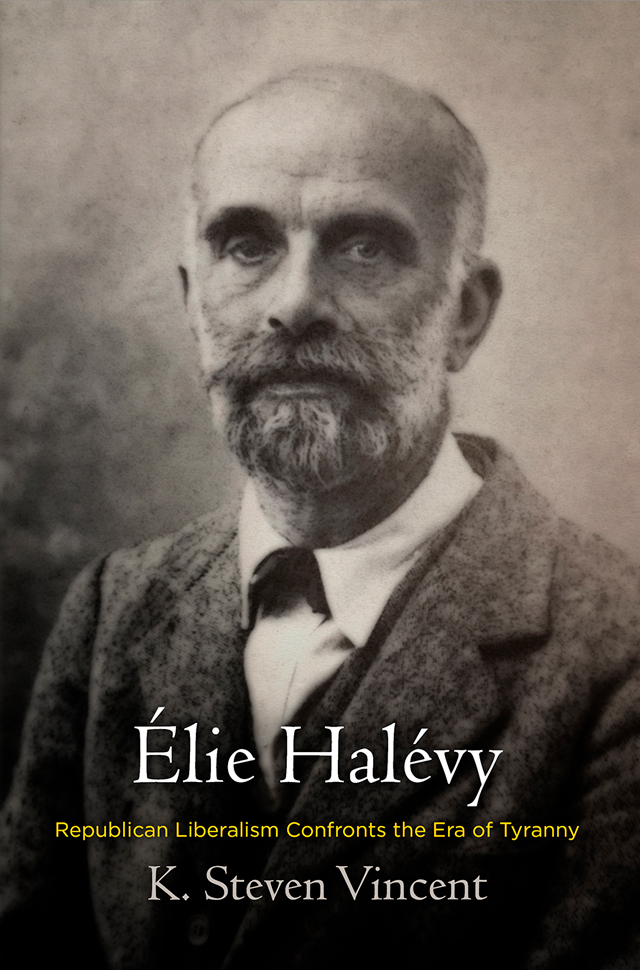
Elie Halevy In this densely contextualized biography, K. Steven Vincent describes how Élie Halévy (1870-1937), one of the most respected and influential intellectuals of the French Third Republic, confronted the Dreyfus Affair, World War I, and the rise of interwar totalitarianism while defending a distinctively French version of liberalism. POLITICAL SCIENCE,Political Ideologies,General
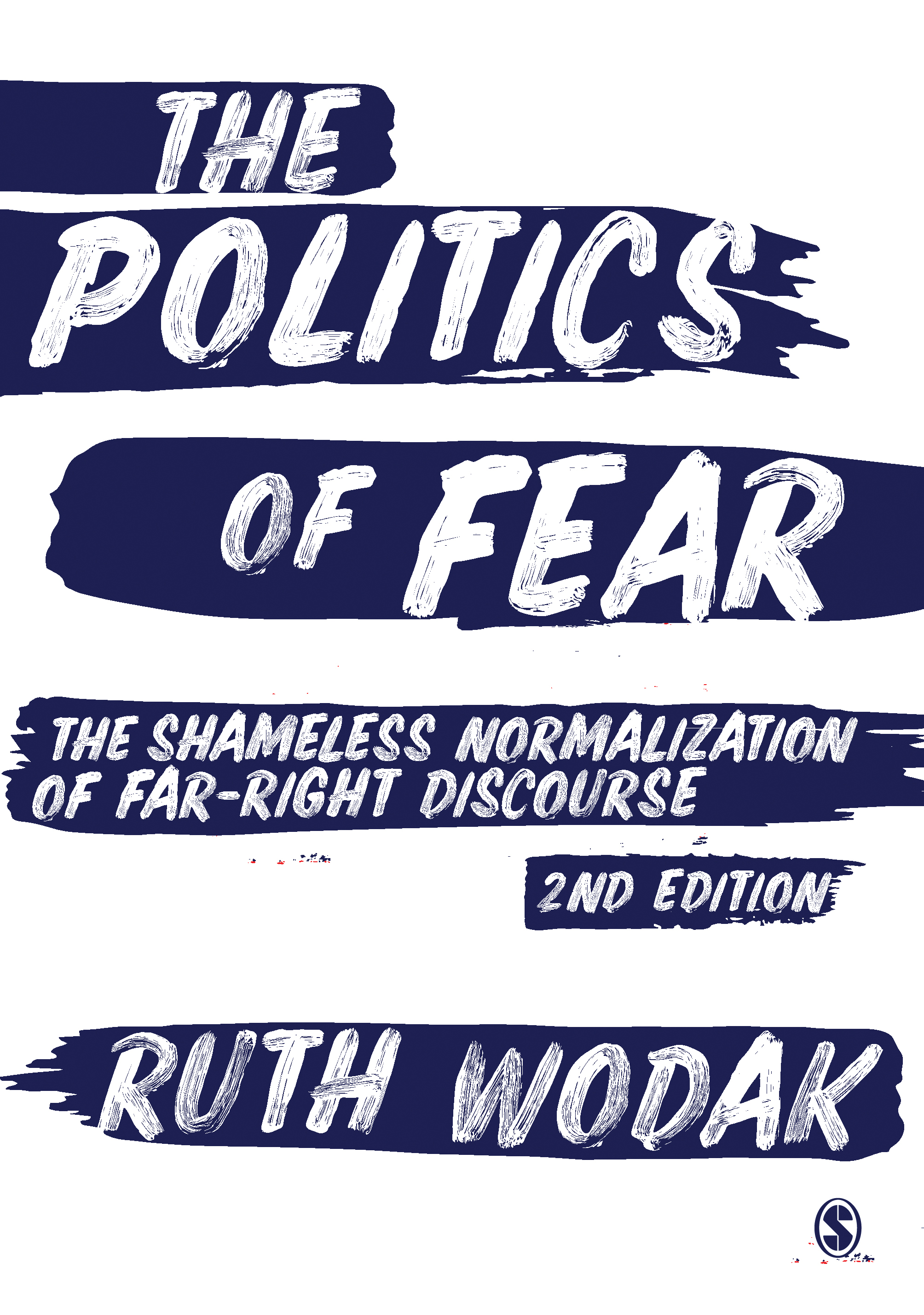
The Politics of Fear The Politics of Fear traces the trajectory of far-right politics from the margins of the political landscape to its very center. It explores the social and historical mechanisms at play, and expertly ties these to the “micro-politics†of far-right language and discourse. POLITICAL SCIENCE,Political Ideologies,General

Polarized America, second edition Updated analysis of how the increasing polarization of American politics has been accompanied and accelerated by greater income inequality. The idea of America as politically polarized—that there is an unbridgeable divide between right and left, red and blue states—has become a cliché. What commentators miss, however, is that increasing polarization has been closely accompanied by fundamental social and economic changes—most notably, a parallel rise in income inequality. In this second edition of Polarized America, Nolan McCarty, Keith Poole, and Howard Rosenthal use the latest data to examine the relationships of polarization, wealth disparity, immigration, and other forces. They find that inequality feeds directly into political polarization, and polarization in turn creates policies that further increase inequality. Paul Krugman called the first edition of Polarized America “Important.... Essential reading for anyone who wants to understand what's happening to America.” The second edition has been thoroughly brought up to date. All statistical analyses, tables, and figures have been updated with data that run through 2012 or 2014, and the text has been revised to reflect the latest evidence. The chapter on campaign finance has been completely rewritten (with Adam Bonica as coauthor); the analysis shows that with so much “soft” money coming from very wealthy ideological extremists, there is even greater campaign contribution inequality than income inequality. POLITICAL SCIENCE,Political Ideologies,General
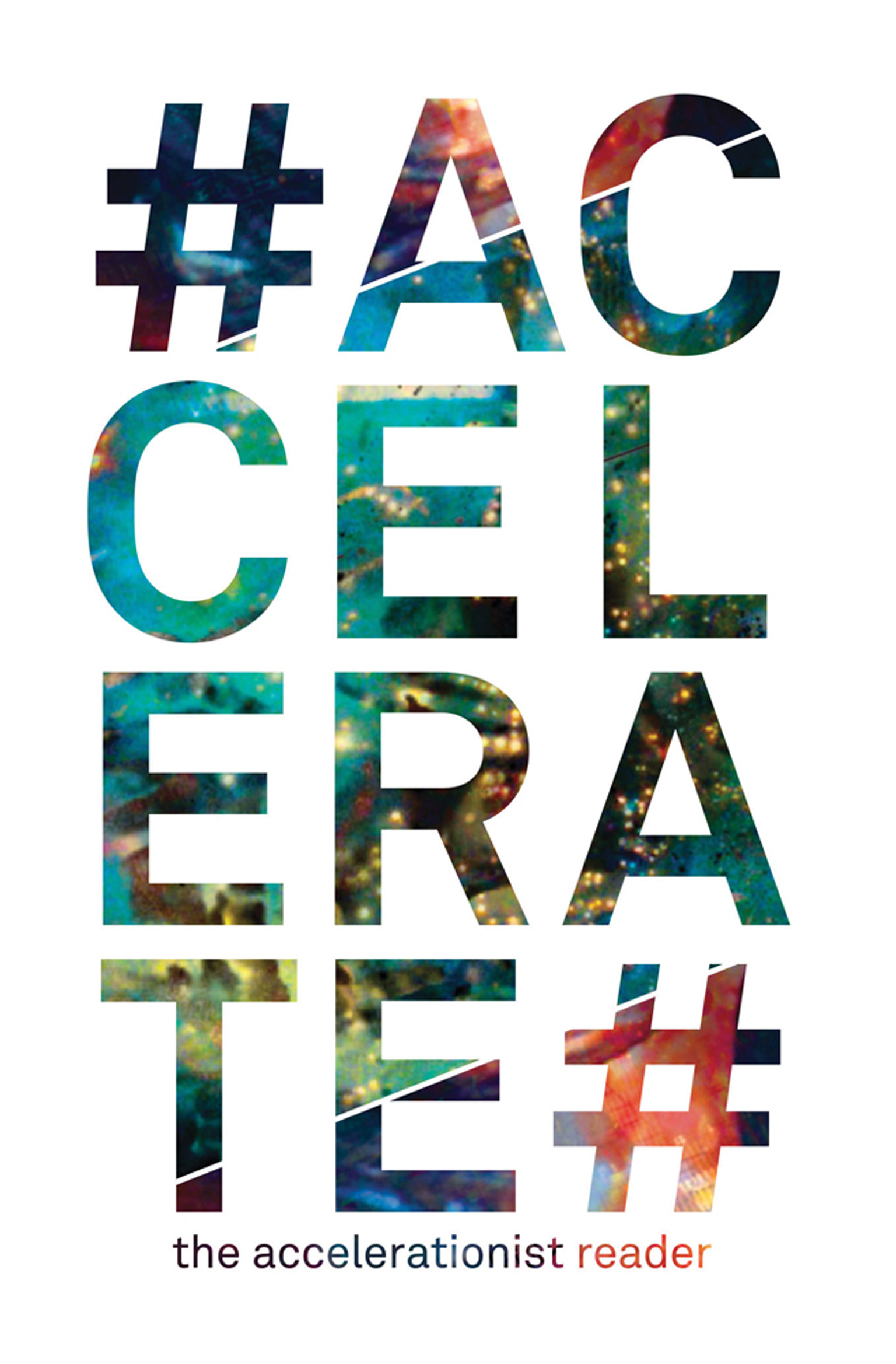
#Accelerate An apparently contradictory yet radically urgent collection of texts tracing the genealogy of a controversial current in contemporary philosophy. Accelerationism is the name of a contemporary political heresy: the insistence that the only radical political response to capitalism is not to protest, disrupt, critique, or détourne it, but to accelerate and exacerbate its uprooting, alienating, decoding, abstractive tendencies. #Accelerate presents a genealogy of accelerationism, tracking the impulse through 90s UK darkside cyberculture and the theory-fictions of Nick Land, Sadie Plant, Iain Grant, and CCRU, across the cultural underground of the 80s (rave, acid house, SF cinema) and back to its sources in delirious post-68 ferment, in texts whose searing nihilistic jouissance would later be disavowed by their authors and the marxist and academic establishment alike. On either side of this central sequence, the book includes texts by Marx that call attention to his own “Prometheanism,” and key works from recent years document the recent extraordinary emergence of new accelerationisms steeled against the onslaughts of neoliberal capitalist realism, and retooled for the twenty-first century. At the forefront of the energetic contemporary debate around this disputed, problematic term, #Accelerate activates a historical conversation about futurality, technology, politics, enjoyment, and capital. This is a legacy shot through with contradictions, yet urgently galvanized today by the poverty of “reasonable” contemporary political alternatives. POLITICAL SCIENCE,Political Ideologies,General
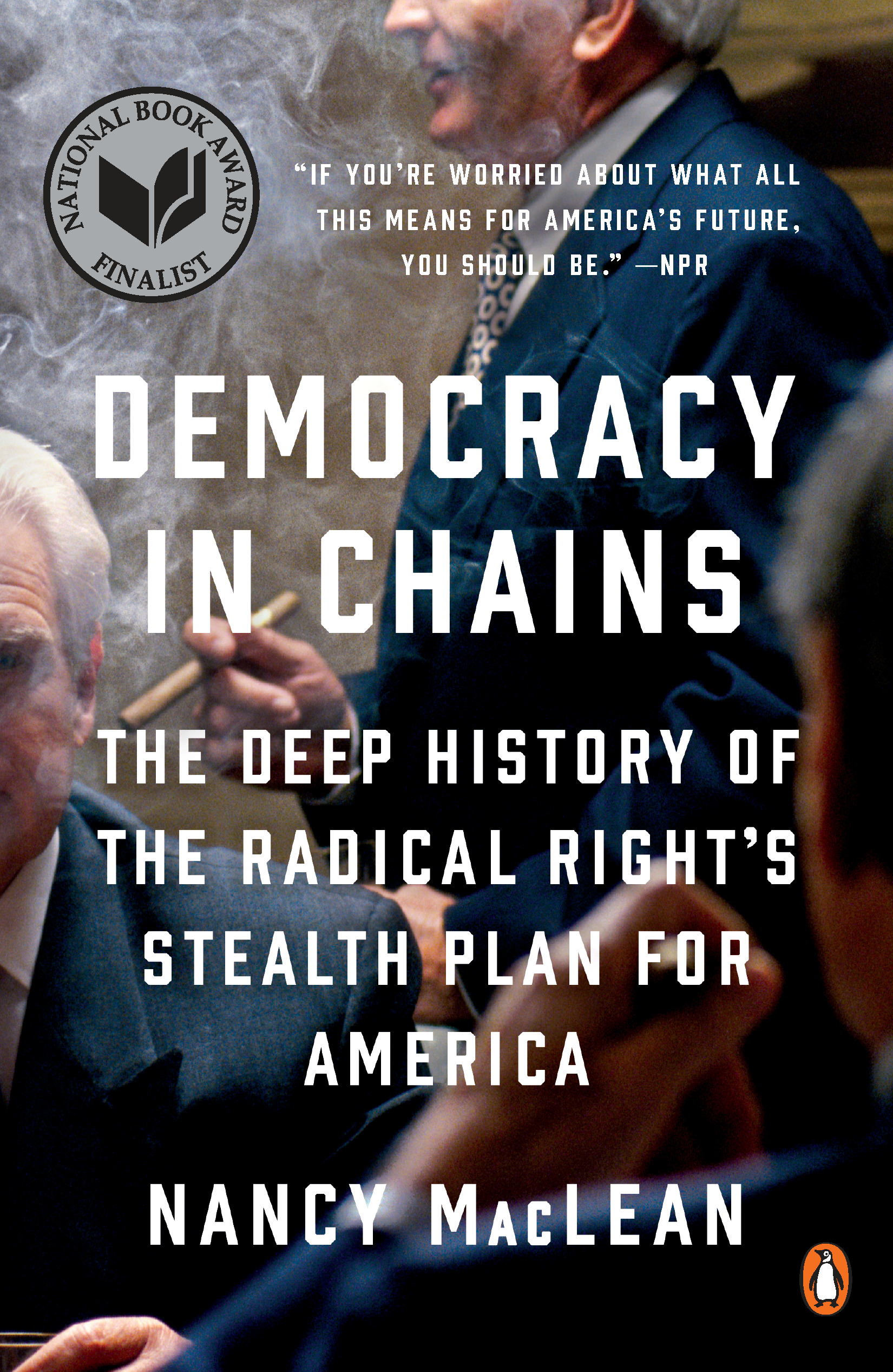
Democracy in Chains Winner of the Lillian Smith Book AwardWinner of the Los Angeles Times Book PrizeFinalist for the National Book Award The Nation's "Most Valuable Book" “[A] vibrant intellectual history of the radical right.” —The Atlantic “This sixty-year campaign to make libertarianism mainstream and eventually take the government itself is at the heart of Democracy in Chains. . . . If you're worried about what all this means for America's future, you should be.” — NPR An explosive exposé of the right’s relentless campaign to eliminate unions, suppress voting, privatize public education, stop action on climate change, and alter the Constitution. Behind today’s headlines of billionaires taking over our government is a secretive political establishment with long, deep, and troubling roots. The capitalist radical right has been working not simply to change who rules, but to fundamentally alter the rules of democratic governance. But billionaires did not launch this movement; a white intellectual in the embattled Jim Crow South did. Democracy in Chains names its true architect—the Nobel Prize-winning political economist James McGill Buchanan—and dissects the operation he and his colleagues designed over six decades to alter every branch of government to disempower the majority. In a brilliant and engrossing narrative, Nancy MacLean shows how Buchanan forged his ideas about government in a last gasp attempt to preserve the white elite’s power in the wake of Brown v. Board of Education. In response to the widening of American democracy, he developed a brilliant, if diabolical, plan to undermine the ability of the majority to use its numbers to level the playing field between the rich and powerful and the rest of us. Corporate donors and their right-wing foundations were only too eager to support Buchanan’s work in teaching others how to divide America into “makers” and “takers.” And when a multibillionaire on a messianic mission to rewrite the social contract of the modern world, Charles Koch, discovered Buchanan, he created a vast, relentless, and multi-armed machine to carry out Buchanan’s strategy. Without Buchanan's ideas and Koch's money, the libertarian right would not have succeeded in its stealth takeover of the Republican Party as a delivery mechanism. Now, with Mike Pence as Vice President, the cause has a longtime loyalist in the White House, not to mention a phalanx of Republicans in the House, the Senate, a majority of state governments, and the courts, all carrying out the plan. That plan includes harsher laws to undermine unions, privatizing everything from schools to health care and Social Security, and keeping as many of us as possible from voting. Based on ten years of unique research, Democracy in Chains tells a chilling story of right-wing academics and big money run amok. This revelatory work of scholarship is also a call to arms to protect the achievements of twentieth-century American self-government. POLITICAL SCIENCE,Political Ideologies,Libertarianism
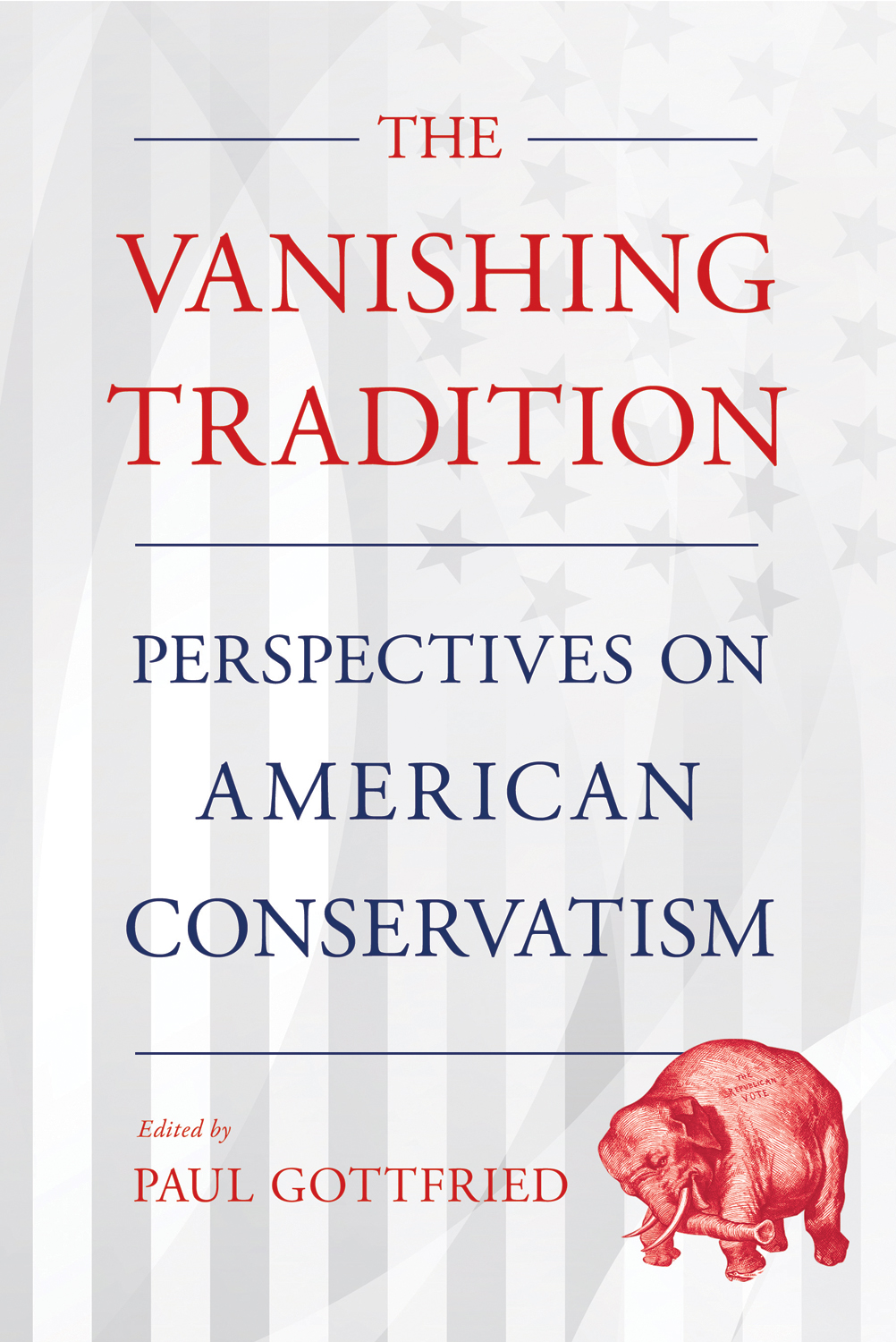
The Vanishing Tradition This anthology provides a timely critical overview of the American conservative movement. The contributors take on subjects that other commentators have either not noticed or have been fearful to discuss. In particular, this collection of searing essays hits hard at blatant cult of celebrity and intolerance of dissent that has come to characterize the conservative movement in this country. As The Vanishing Tradition shows, the conservative movement has not often retrieved its wounded, instead dispatching them in order to please its friendly opposition and to prove its "moderateness." The movement has also been open to the influence of demanding sponsors who have pushed it in sometimes bizarre directions. Finally, the essayists here, highlight the movement's appeal to "permanent values" as a truly risible gesture, given how arduously its celebrities have worked to catch up with the Left on social issues. This no-holds-barred critical examination of American conservatism opens debates and seeks controversy. POLITICAL SCIENCE,Political Ideologies,Libertarianism
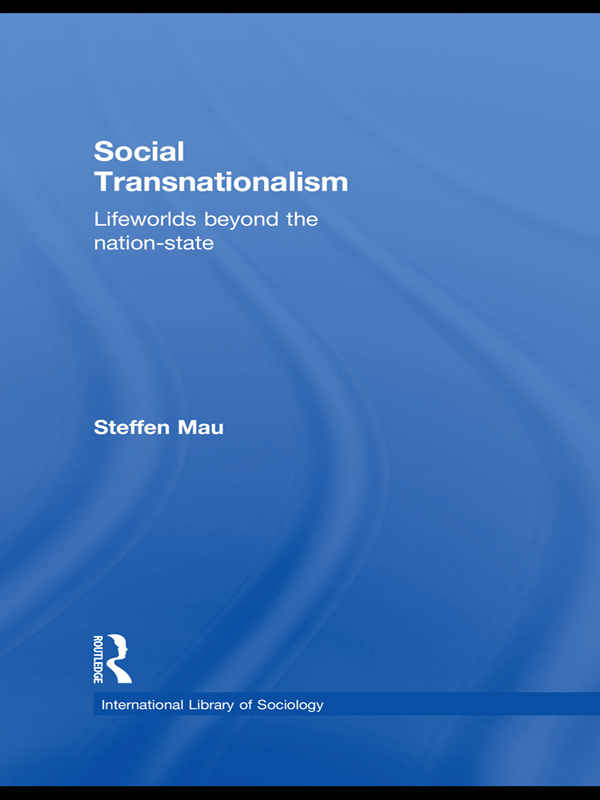
Social Transnationalism In recent decades, the rise of world markets and the technological revolutions in transportation and communication have brought what was once distant and inaccessible within easy reach of the individual. The territorial and social closure that characterized nation-states is fading, and this is reflected not only in new forms of governance and economic globalization, but also in individual mobility and transnational transactions, affiliations and networks. Social Transnationalism explores new forms of cross-border interactions and mobility which have expanded across physical space by looking at the individual level. It asks whether we are dealing with unbridled movements and cross-border interactions which transform the lifeworlds of individuals fundamentally. Furthermore, it investigates whether, and to what degree, increases in the volume of transnational interactions weaken the individual citizen's bond to the nation-state as such, and to what extent citizens' national identities are being replaced or complemented by cosmopolitan ones POLITICAL SCIENCE,Political Ideologies,Nationalism & Patriotism

The Value of Nothing Raj Patel, the author of Stuffed and Starved, is an activist and an academic who has been hailed as "a visionary" for his prescience about the food crisis and solutions to it. POLITICAL SCIENCE,Political Ideologies,Nationalism & Patriotism
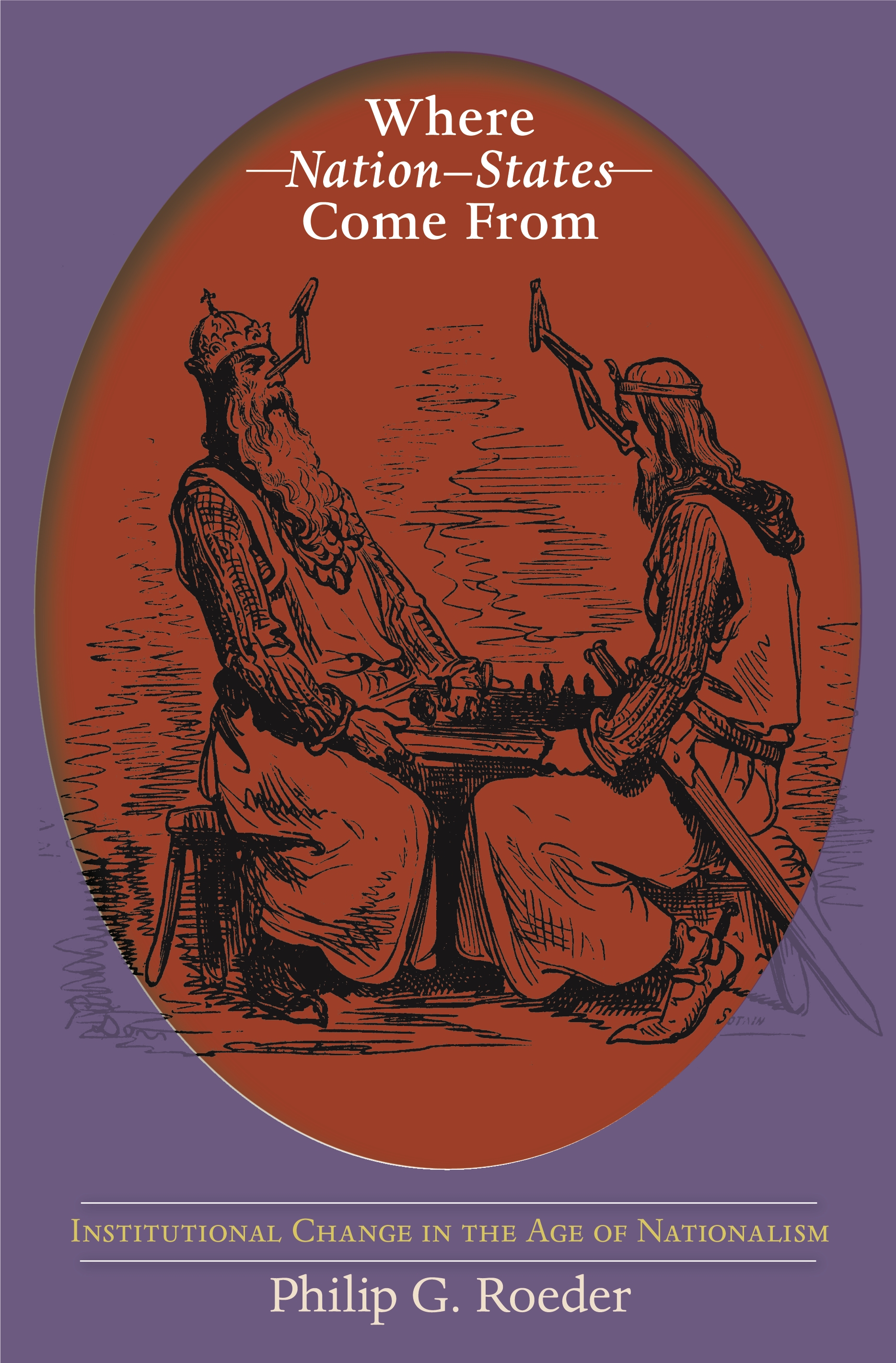
Where Nation-States Come From To date, the world can lay claim to little more than 190 sovereign independent entities recognized as nation-states, while by some estimates there may be up to eight hundred more nation-state projects underway and seven to eight thousand potential projects. Why do a few such endeavors come to fruition while most fail? Standard explanations have pointed to national awakenings, nationalist mobilizations, economic efficiency, military prowess, or intervention by the great powers. Where Nation-States Come From provides a compelling alternative account, one that incorporates an in-depth examination of the Russian Empire, the Soviet Union, and their successor states. Philip Roeder argues that almost all successful nation-state projects have been associated with a particular political institution prior to independence: the segment-state, a jurisdiction defined by both human and territorial boundaries. Independence represents an administrative upgrade of a segment-state. Before independence, segmental institutions shape politics on the periphery of an existing sovereign state. Leaders of segment-states are thus better positioned than other proponents of nation-state endeavors to forge locally hegemonic national identities. Before independence, segmental institutions also shape the politics between the periphery and center of existing states. Leaders of segment-states are hence also more able to challenge the status quo and to induce the leaders of the existing state to concede independence. Roeder clarifies the mechanisms that link such institutions to outcomes, and demonstrates that these relationships have prevailed around the world through most of the age of nationalism. POLITICAL SCIENCE,Political Ideologies,Nationalism & Patriotism

Trans-pacific Imagination, The This anthology critically re-examines and re-articulates the discursive boundary that binds the region called East Asia in order to produce Trans-Pacific Studies. Recognizing that the creation of regional boundaries depends on a new configuration of both inter- and intra-national power relations and the ideological constructs that generate historical, ideological, and cultural effects, this volume proposes that the term “trans-Pacific†be mobilized to complicate the phrase “East Asian†as the boundary of academic discipline and socio-cultural discourse. The anthology also examines the historical conditions under which “East Asia†was constructed as an area and the trans-Pacific directives that nurtured the sense of nationality in each component nation of East Asia.With the contribution of: Sun Ge (The Institute of Literature, Chinese Academy of Social Sciences); Soyoung Kim (Korean National University of Arts); Hyoduk Lee (Tokyo University of Foreign Studies); Jie-Hyun Lim (Hanyang University); Lisa Lowe (University of California); Tessa Morris-Suzuki (The Australian National University); Naoki Sakai (Cornell University), Yuko Shibata (Saint John's University); Annmaria Shimabuku (University of California); Ikuo Shinjou (University of the Ryukyus); Hyon Joo Yoo (University of Vermont). POLITICAL SCIENCE,Political Ideologies,Nationalism & Patriotism
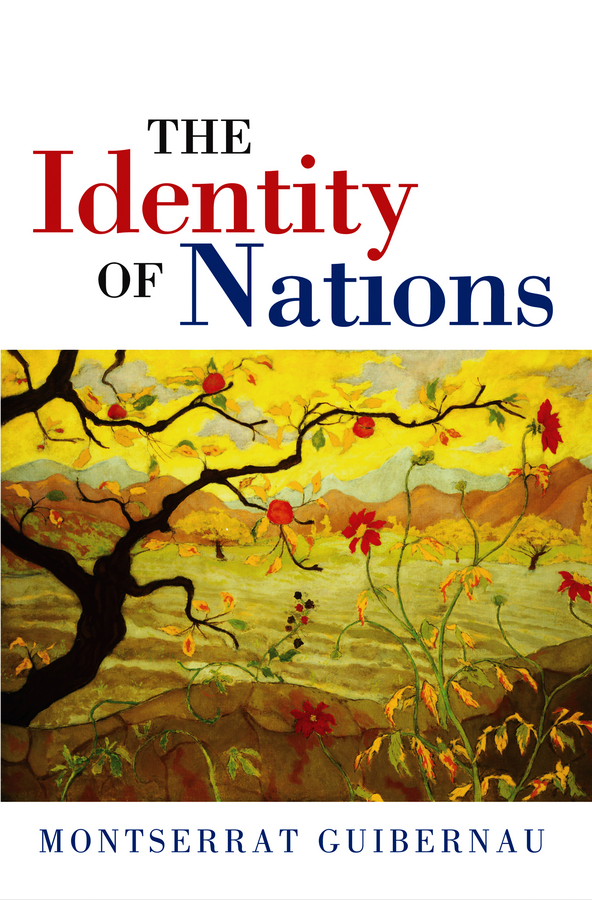
The Identity of Nations What is national identity? What are the main challenges posed to national identity by the strengthening of regional identities and the growth of cultural diversity? How is right-wing nationalism connected to the desire to preserve a traditional image of national identity? Can we forge a new kind of national identity that responds to the challenges of globalization and other deep-seated changes? In this important new book, Montserrat Guibernau answers these and other compelling questions about the future of national identity. For Guibernau, the nation-states traditional project to unify its otherwise diverse population by generating a shared sense of national identity among them was always contested, and was accomplished with various degrees of success in Europe and North America. Such processes involved the cultural and linguistic homogenization of an otherwise diverse citizenry and were pursued by different means according to the specific contexts within which they were applied. At present, the impact of strong structural socio-political and economic transformations has resulted in greater challenges being posed to the idea that all citizens of a state should share a homogeneous national identity. Diversity is increasing, and plans for further European integration contain the potential to generate significant tensions, casting greater doubt on the classical concept of national identity. As a result, we are faced with a set of new dilemmas concerning the way in which national identity is constructed and defined. The book offers a theoretical as well as a comparative approach, with case studies involving Austria, Britain, Canada and Spain, as well as the European Union and the United States of America. The Identity of Nations will be essential reading for advanced students and professional scholars in sociology, politics and international relations. POLITICAL SCIENCE,Political Ideologies,Nationalism & Patriotism

Nationalism For the last two centuries, nationalism has been a central feature of society and politics. Few ideologies can match its power and resonance, and no other political movement and symbolic language has such worldwide appeal and resilience. But nationalism is also a form of public culture and political religion, which draws on much older cultural and symbolic forms. Seeking to do justice to these different facets of nationalism, the second edition of this popular and respected overview has been revised and updated with contemporary developments and the latest scholarly work. It aims to provide a concise and accessible introduction to the core concepts and varieties of nationalist ideology; a clear analysis of the major competing paradigms and theories of nations and nationalism; a critical account of the often opposed histories and periodization of the nation and nationalism; and an assessment of the prospects of nationalism and its continued global power and persistence. Broad and comparative in scope, the book is strongly interdisciplinary, drawing on ideas and insights from history, political science, sociology and anthropology. The focus is theoretical, but it also includes a fresh examination of some of the main historical and contemporary empirical contributions to the literature on the subject. It will continue to be an invaluable resource for students of nationalism across the social sciences. POLITICAL SCIENCE,Political Ideologies,Nationalism & Patriotism
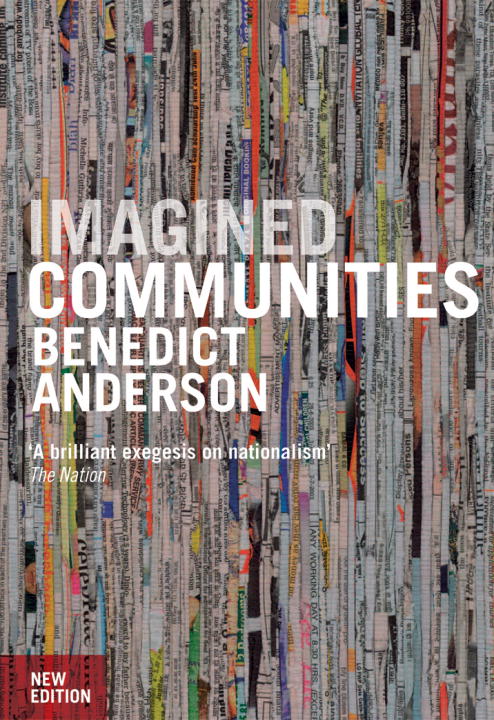
Imagined Communities The world-famous work on the origins and development of nationalism The full magnitude of Benedict Anderson’s intellectual achievement is still being appreciated and debated. Imagined Communities remains the most influential book on the origins of nationalism, filling the vacuum that previously existed in the traditions of Western thought. Cited more often than any other single English-language work in the human sciences, it is read around the world in more than thirty translations. Written with exemplary clarity, this illuminating study traces the emergence of community as an idea to South America, rather than to nineteenth-century Europe. Later, this sense of belonging was formed and reformulated at every level, from high politics to popular culture, through print, literature, maps and museums. Following the rise and conflict of nations and the decline of empires, Anderson draws on examples from South East Asia, Latin America and Europe’s recent past to show how nationalism shaped the modern world. POLITICAL SCIENCE,Political Ideologies,Nationalism & Patriotism

Nations without States Guibernau offers a comparative analysis of nationalist movements in nations without states. POLITICAL SCIENCE,Political Ideologies,Nationalism & Patriotism

Angry White People The true story of the causes driving social discontent and racism in Britain today. POLITICAL SCIENCE,Political Ideologies,Nationalism & Patriotism
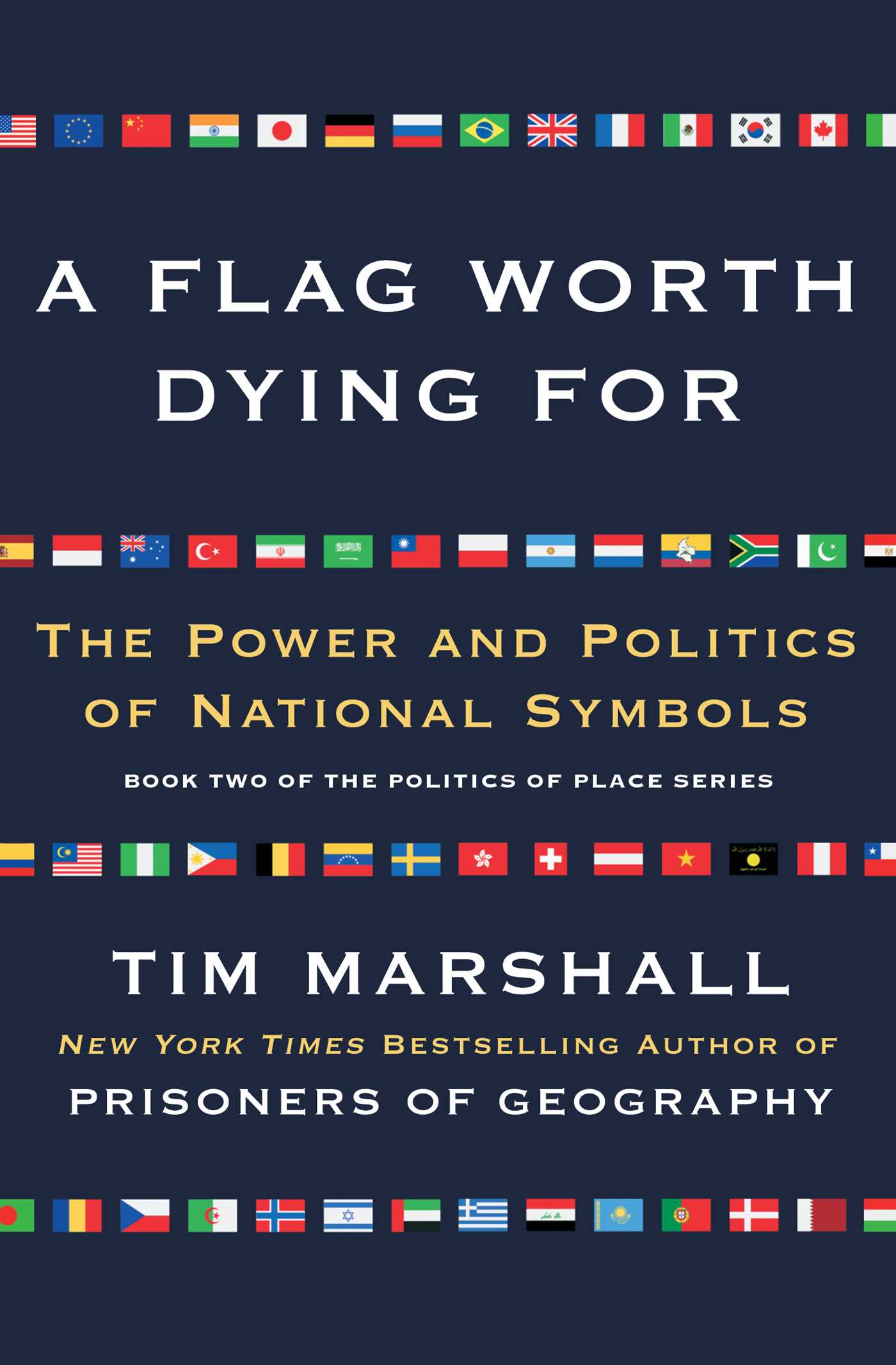
A Flag Worth Dying For Combining keen analysis of current events with world history, Tim Marshall, author of the New York Times bestseller Prisoners of Geography, provides “an entertaining whistle-stop tour of world flags†(Library Journal)—how their power is used to unite and divide populations and intimidate enemies. For thousands of years flags have represented our hopes and dreams. We wave them. Burn them. March under their colors. And still, in the twenty-first century, we die for them. Flags fly at the UN, on Arab streets, from front porches in Texas. They represent the politics of high power as well as the politics of the mob. From the renewed sense of nationalism in China, to troubled identities in Europe and the USA, to the terrifying rise of Islamic State, the world is a confusing place right now and it’s important to understand the symbols, old and new, that people are rallying around. In nine chapters (covering the USA, UK, Europe, Middle East, Asia, Africa, Latin America, international flags, and flags of terror), Tim Marshall’s A Flag Worth Dying For is a “brisk, entertaining read…that successfully answers a puzzling question: how can a simple piece of cloth come to mean so much? Marshall presents an informative survey of these highly visible symbols of national or international pride†(Publishers Weekly), representing nation states and non-state actors (including ISIS, Hezbollah, and Hamas), and explains how they figure in diplomatic relations and events today. Drawing on more than twenty-five years of global reporting experience to reveal the true meaning behind the symbols that unite us—and divide us—Marshall “writes with the cool drollery that characterized the work of Christopher Hitchens of Simon Winchester†(USA TODAY). The “illuminating†(The New York Times) A Flag Worth Dying For is a winning combination of current affairs, politics, and world history and “a treasure vault for vexillologists, full of meaning beyond the hue and thread of the world’s banners†(Kirkus Reviews). POLITICAL SCIENCE,Political Ideologies,Nationalism & Patriotism
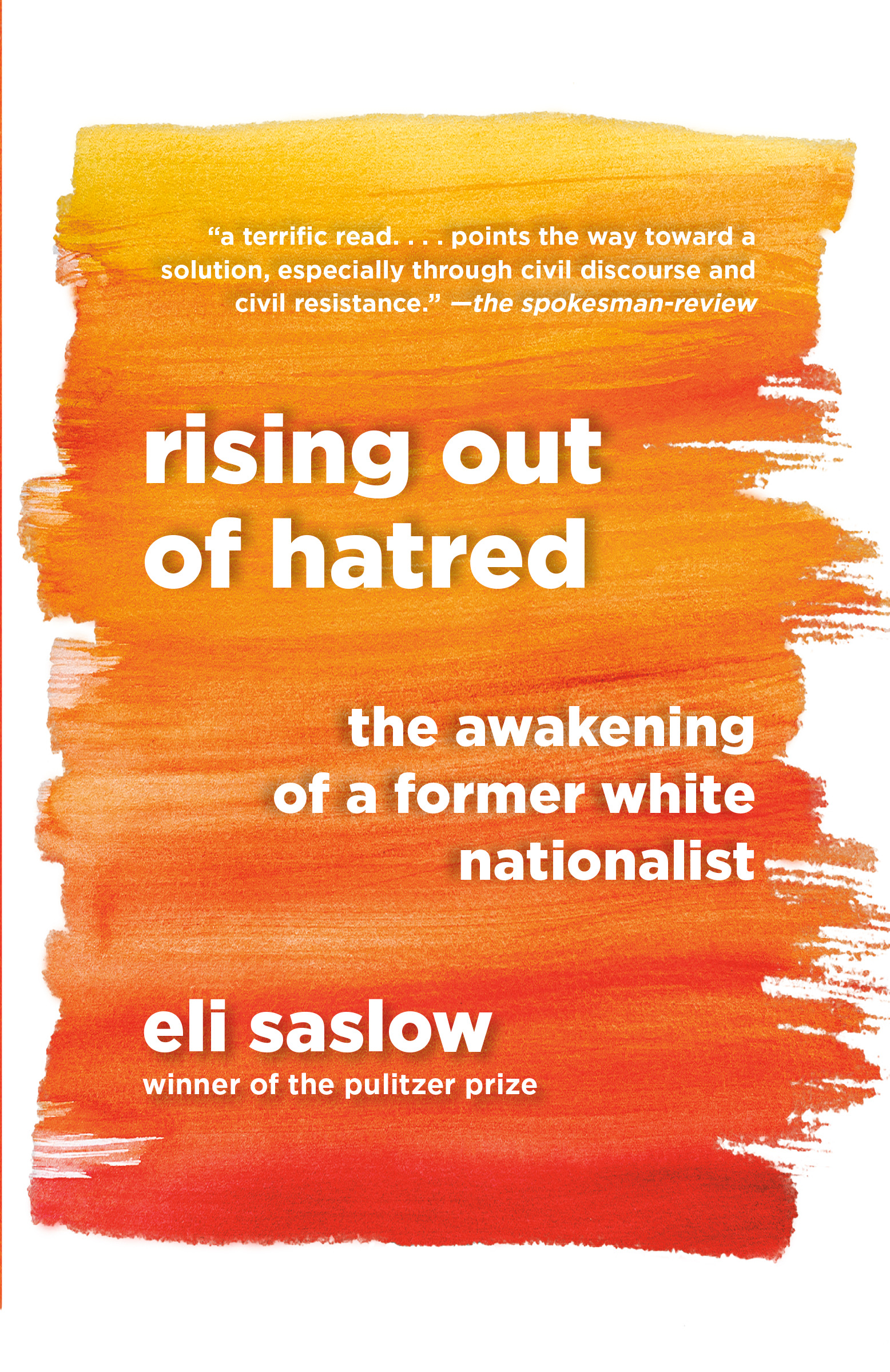
Rising Out of Hatred From a Pulitzer Prize-winning reporter, the powerful story of how a prominent white supremacist changed his heart and mind. This is a book to help us understand the American moment and to help us better understand one another. Derek Black grew up at the epicenter of white nationalism. His father founded Stormfront, the largest racist community on the Internet. His godfather, David Duke, was a KKK Grand Wizard. By the time Derek turned nineteen, he had become an elected politician with his own daily radio show—already regarded as the "the leading light" of the burgeoning white nationalist movement. "We can infiltrate," Derek once told a crowd of white nationalists. "We can take the country back." Then he went to college. At New College of Florida, he continued to broadcast his radio show in secret each morning, living a double life until a classmate uncovered his identity and sent an email to the entire school. "Derek Black ... white supremacist, radio host ... New College student???" The ensuing uproar overtook one of the most liberal colleges in the country. Some students protested Derek's presence on campus, forcing him to reconcile for the first time with the ugliness of his beliefs. Other students found the courage to reach out to him, including an Orthodox Jew who invited Derek to attend weekly Shabbat dinners. It was because of those dinners—and the wide-ranging relationships formed at that table—that Derek started to question the science, history, and prejudices behind his worldview. As white nationalism infiltrated the political mainstream, Derek decided to confront the damage he had done. Rising Out of Hatred tells the story of how white-supremacist ideas migrated from the far-right fringe to the White House through the intensely personal saga of one man who eventually disavowed everything he was taught to believe, at tremendous personal cost. With great empathy and narrative verve, Eli Saslow asks what Derek Black's story can tell us about America's increasingly divided nature. POLITICAL SCIENCE,Political Ideologies,Nationalism & Patriotism
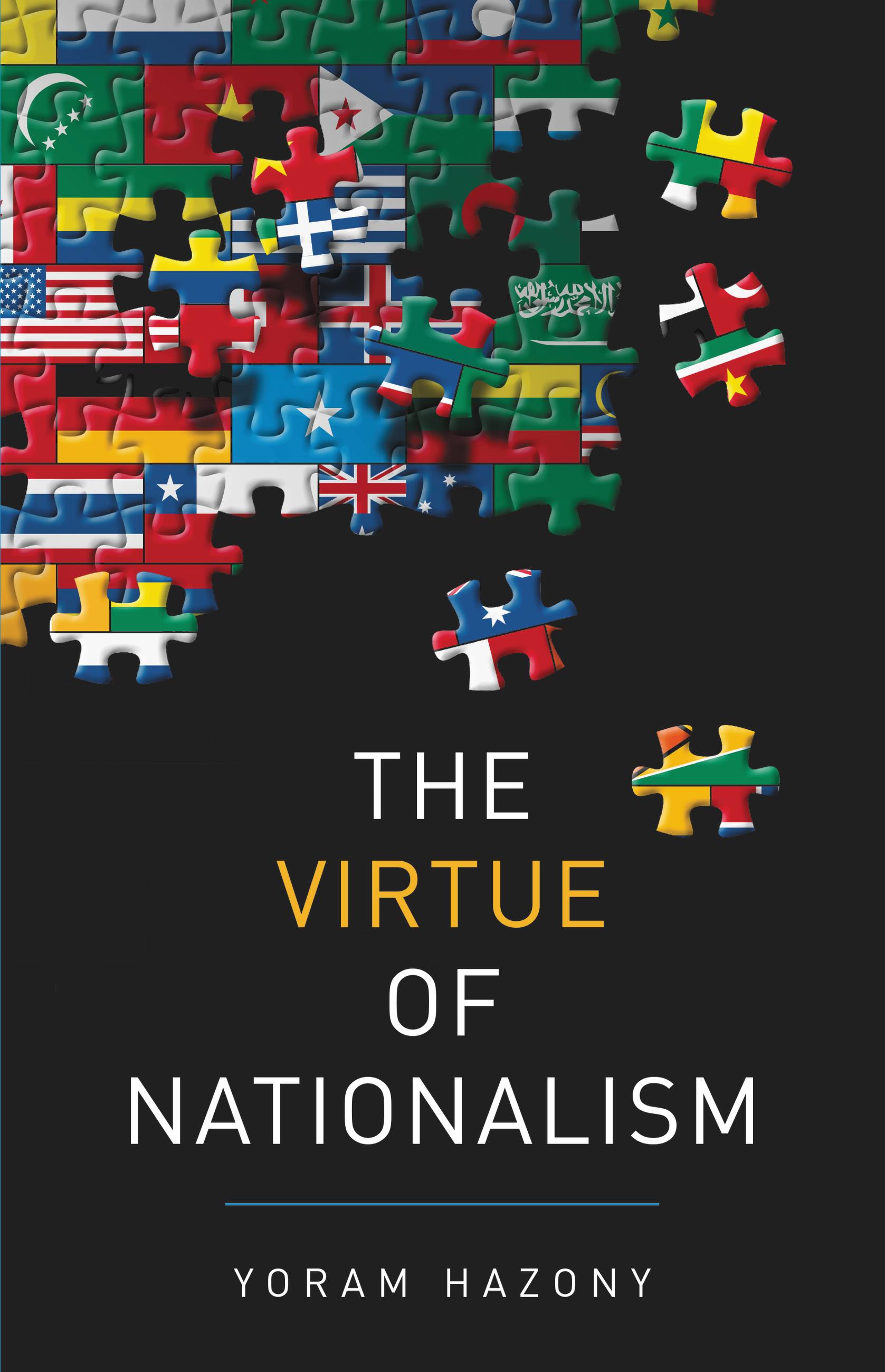
The Virtue of Nationalism A leading conservative thinker argues that a nationalist order is the only realistic safeguard of liberty in the world today Nationalism is the issue of our age. From Donald Trump's "America First" politics to Brexit to the rise of the right in Europe, events have forced a crucial debate: Should we fight for international government? Or should the world's nations keep their independence and self-determination? In The Virtue of Nationalism, Yoram Hazony contends that a world of sovereign nations is the only option for those who care about personal and collective freedom. He recounts how, beginning in the sixteenth century, English, Dutch, and American Protestants revived the Old Testament's love of national independence, and shows how their vision eventually brought freedom to peoples from Poland to India, Israel to Ethiopia. It is this tradition we must restore, he argues, if we want to limit conflict and hate -- and allow human difference and innovation to flourish. POLITICAL SCIENCE,Political Ideologies,Nationalism & Patriotism
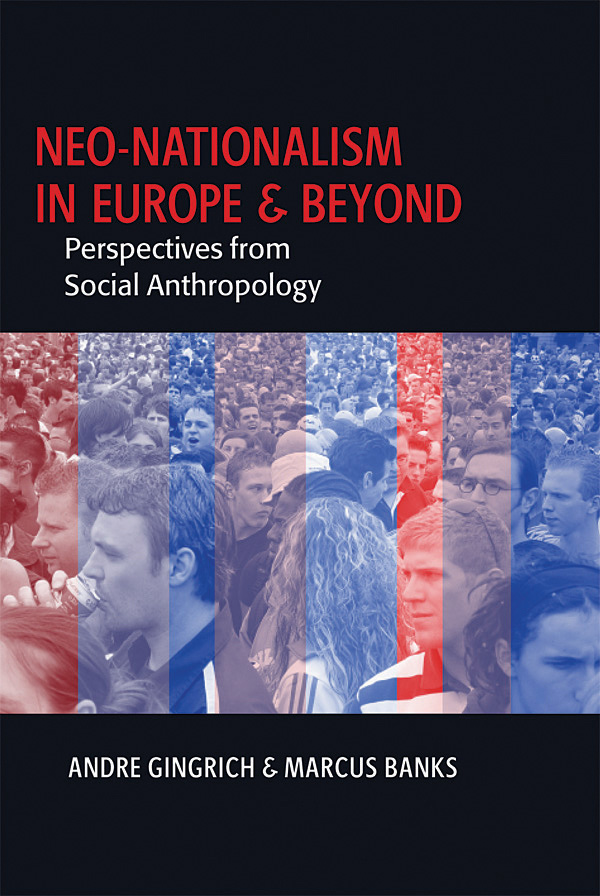
Neo-nationalism in Europe and Beyond By the early twenty-first century neo-nationalist forces have established themselves in a number of the world’s large regions and subcontinents. From Australia to South Asia, in Eastern and Western Europe, comparable parties and movements have positioned themselves in national parliaments and governments, with some considerable impact on state power. In contrast to right-wing extremist parties in the past, these recent movements mostly operate within legal parliamentary channels, using essentialized notions of local culture to mobilize against real and alleged threats to local identities of status, gender, religion, nationhood and ethnicity. Prompted by this near-simultaneous rise to political influence of more than a dozen apparently similar parties across Western Europe, this collection offers a range of European case studies with selected global examples, such as the Front National, the late Pim Fortuyn, India and the BJP, and Pauline Hanson and her One Nation Party in Australia. It takes up the theoretical and methodological challenges posed by this phenomenon and asks what distinctive contributions anthropology might make to its study. POLITICAL SCIENCE,Political Ideologies,Nationalism & Patriotism

The Identitarians The Identitarians investigates the far-right anti-globalist and anti-Islamic movement on both sides of the Atlantic. POLITICAL SCIENCE,Political Ideologies,Nationalism & Patriotism

Chechnya The conflict in Chechnya involves many of the most contentious issues in contemporary international politics. By providing us with a persuasive and challenging study, Hughes sets out the indispensable lessons for other conflicts involving the volatile combination of insurgency and counterinsurgency, most notably the wars in Iraq and Afghanistan. POLITICAL SCIENCE,Political Ideologies,Nationalism & Patriotism
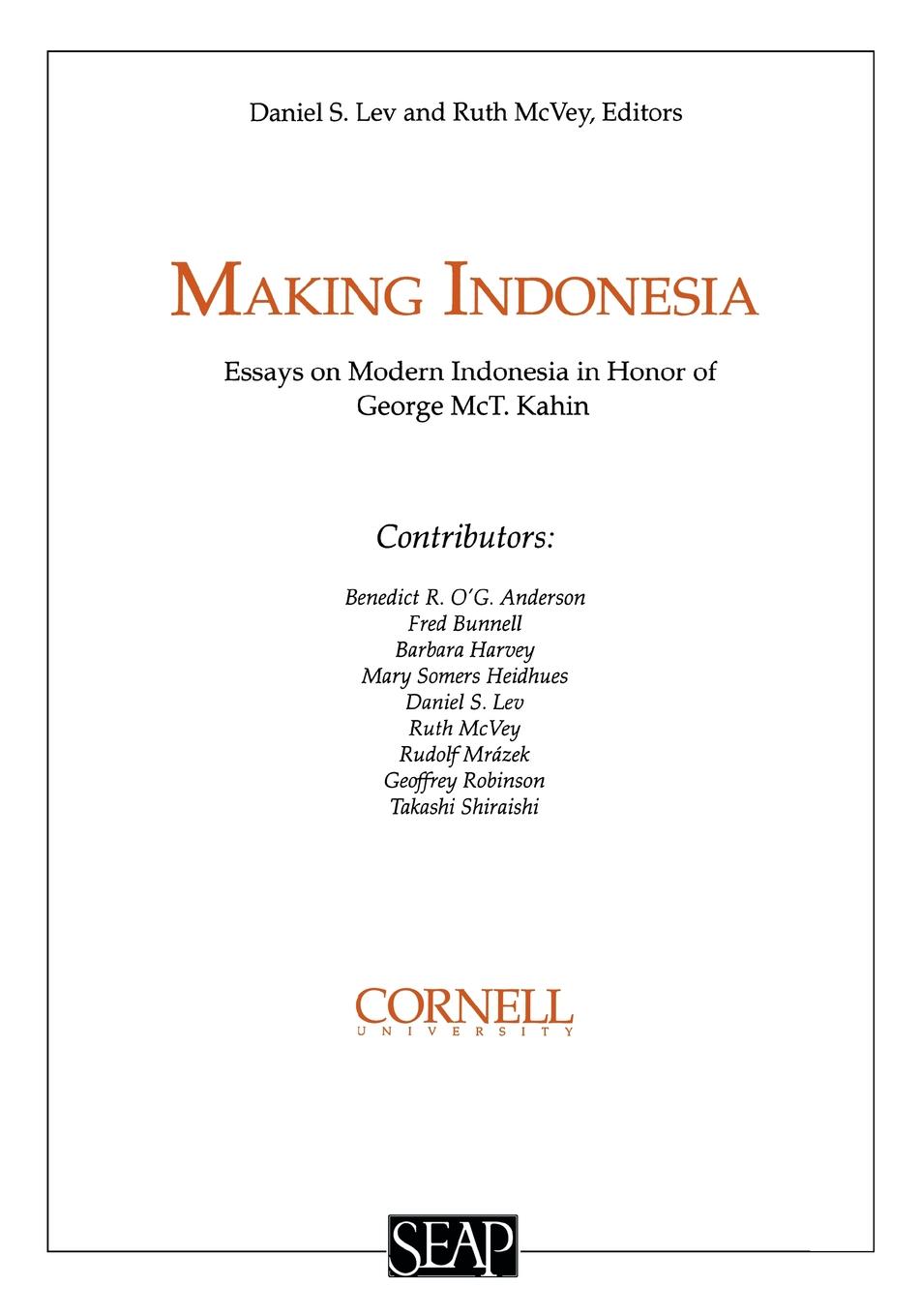
Making Indonesia Dedicated to George McT. Kahin, this collection examines the genesis and evolution of the modern Indonesian nation-state. Essay topics range from the nation's imaginative conception to the Suharto government's political and financial infrastructure... POLITICAL SCIENCE,Political Ideologies,Nationalism & Patriotism
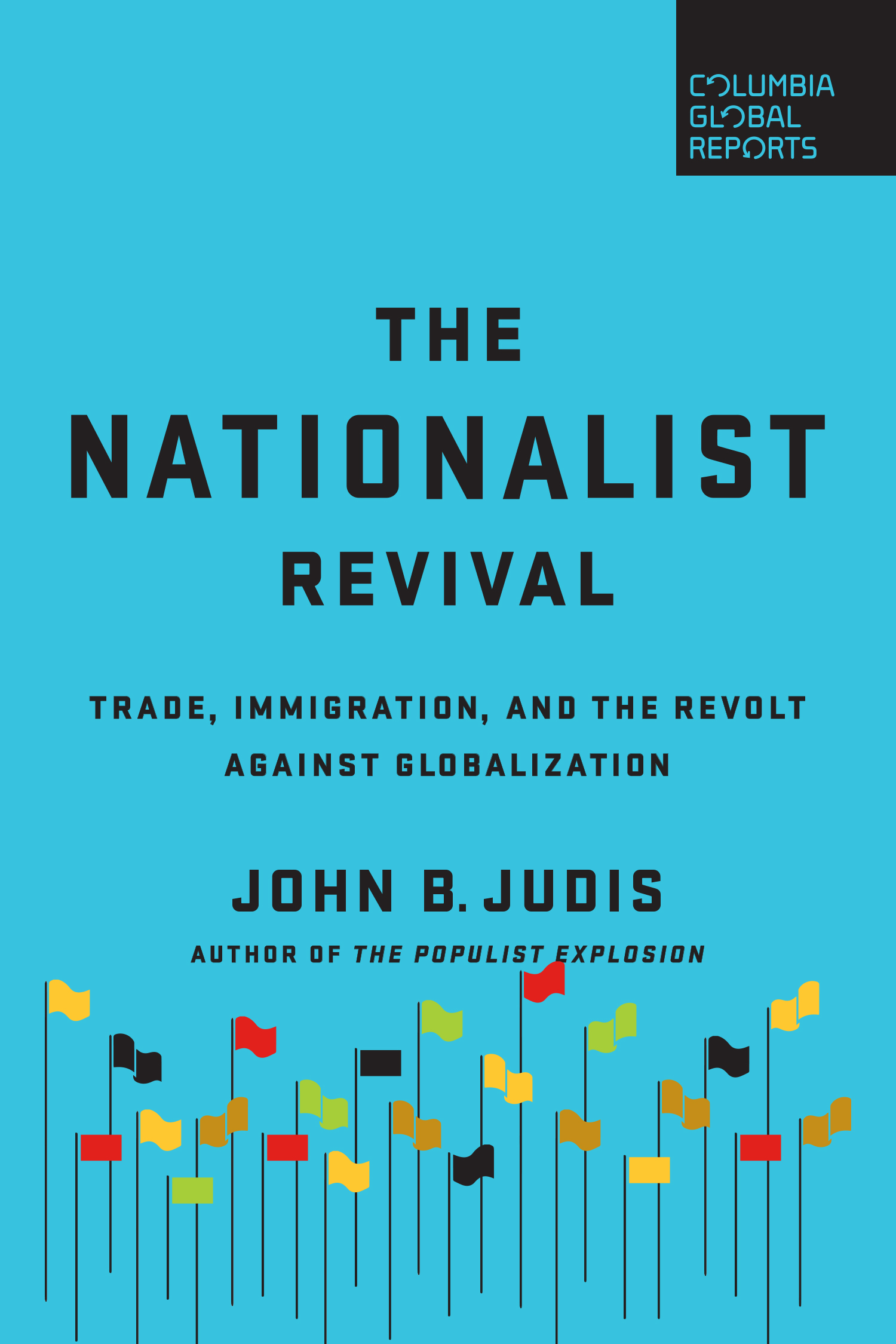
The Nationalist Revival "Excellent and compact....He thinks it's important for progressives to understand why so many are drawn to Trump and the far right in Europe." -- E.J. Dionne, The Washington Post Trump in America, Johnson in the U.K., anti-EU parties in Italy, Germany, France, the Netherlands, Austria, Poland, and Hungary, and nativist or authoritarian leaders in Turkey, Russia, India, and China -- Why has nationalism suddenly returned with a vengeance? Is the world headed back to the fractious conflicts between nations that led to world wars and depression in the early 20th Century? Based on travels in America, Europe, and Asia, veteran political analyst John B. Judis found that almost all people share nationalist sentiments that can be the basis of vibrant democracies as well as repressive dictatorships. Today's outbreak of toxic "us vs. them" nationalism is an extreme reaction to utopian cosmopolitanism, which advocates open borders, free trade, rampant outsourcing, and has branded nationalist sentiments as bigotry. Can a new international order be created that doesn't dismiss what is constructive about nationalism? As he does for populism in The Populist Explosion, and for socialism in The Socialist Awakening, Judis looks at nationalism from its modern origins in the 1800s to today to find answers. "John B. Judis does not see a death-match between imperial liberalism on the one hand and nationalism on the other. His book argues that elites have overreached, both in the U.S. and in Europe....Mr. Judis--who has long supported progressive and pro-labor economic policies--calls for a synthesis between liberalism and nationalism." -- The Wall Street Journal POLITICAL SCIENCE,Political Ideologies,Nationalism & Patriotism
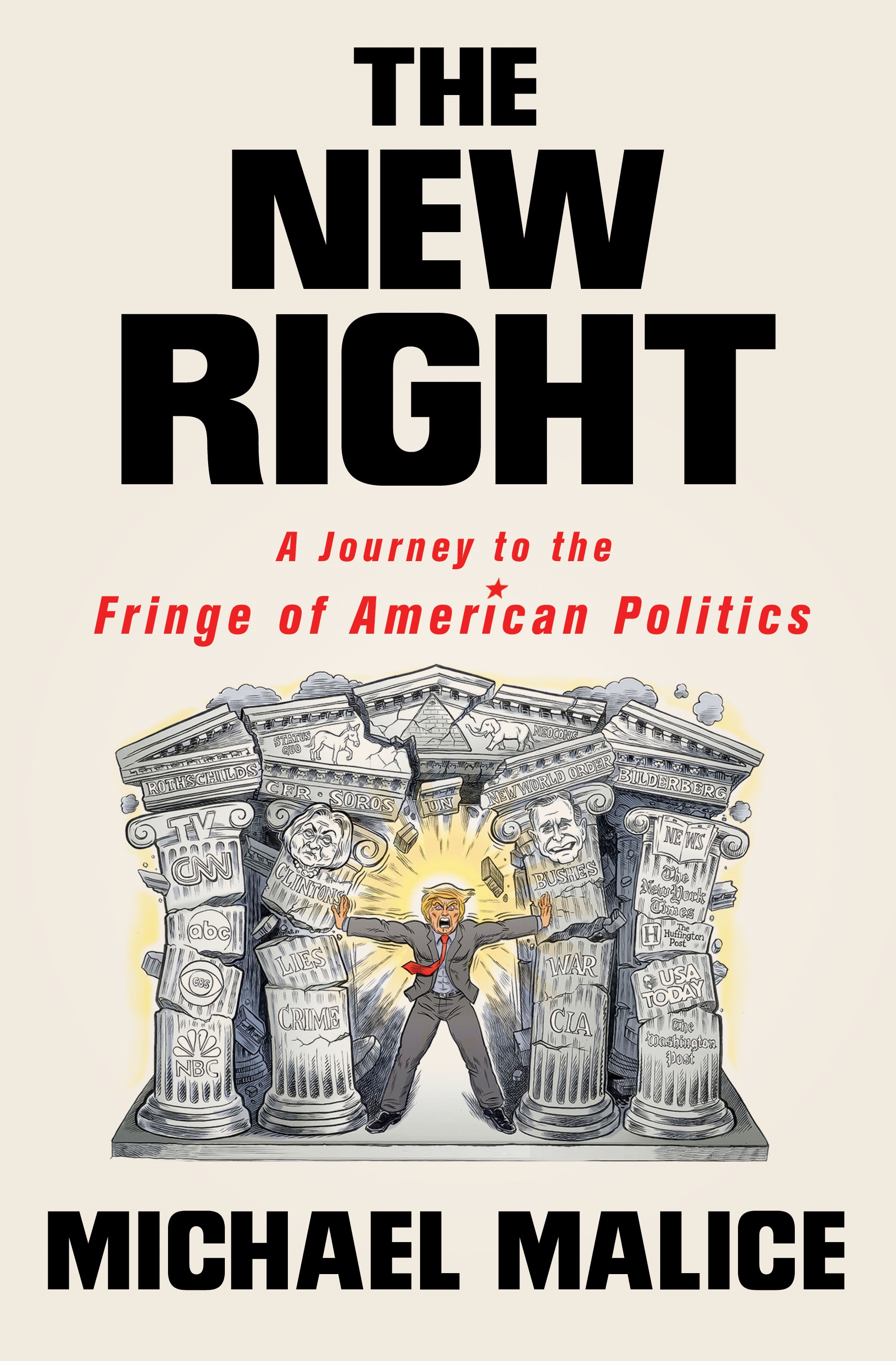
The New Right The definitive firsthand account of the movement that permanently broke the American political consensus. What do internet trolls, economic populists, white nationalists, techno-anarchists and Alex Jones have in common? Nothing, except for an unremitting hatred of evangelical progressivism and the so-called “Cathedral†from whence it pours forth. Contrary to the dissembling explanations from the corporate press, this movement did not emerge overnight—nor are its varied subgroups in any sense interchangeable with one another. As united by their opposition as they are divided by their goals, the members of the New Right are willfully suspicious of those in the mainstream who would seek to tell their story. Fortunately, author Michael Malice was there from the very inception, and in The New Right recounts their tale from the beginning. Malice provides an authoritative and unbiased portrait of the New Right as a movement of ideas—ideas that he traces to surprisingly diverse ideological roots. From the heterodox right wing of the 1940s to the Buchanan/Rothbard alliance of 1992 and all the way through to what he witnessed personally in Charlottesville, The New Right is a thorough firsthand accounting of the concepts, characters and chronology of this widely misunderstood sociopolitical phenomenon. Today’s fringe is tomorrow’s orthodoxy. As entertaining as it is informative, The New Right is required reading for every American across the spectrum who would like to learn more about the past, present and future of our divided political culture. POLITICAL SCIENCE,Political Ideologies,Nationalism & Patriotism
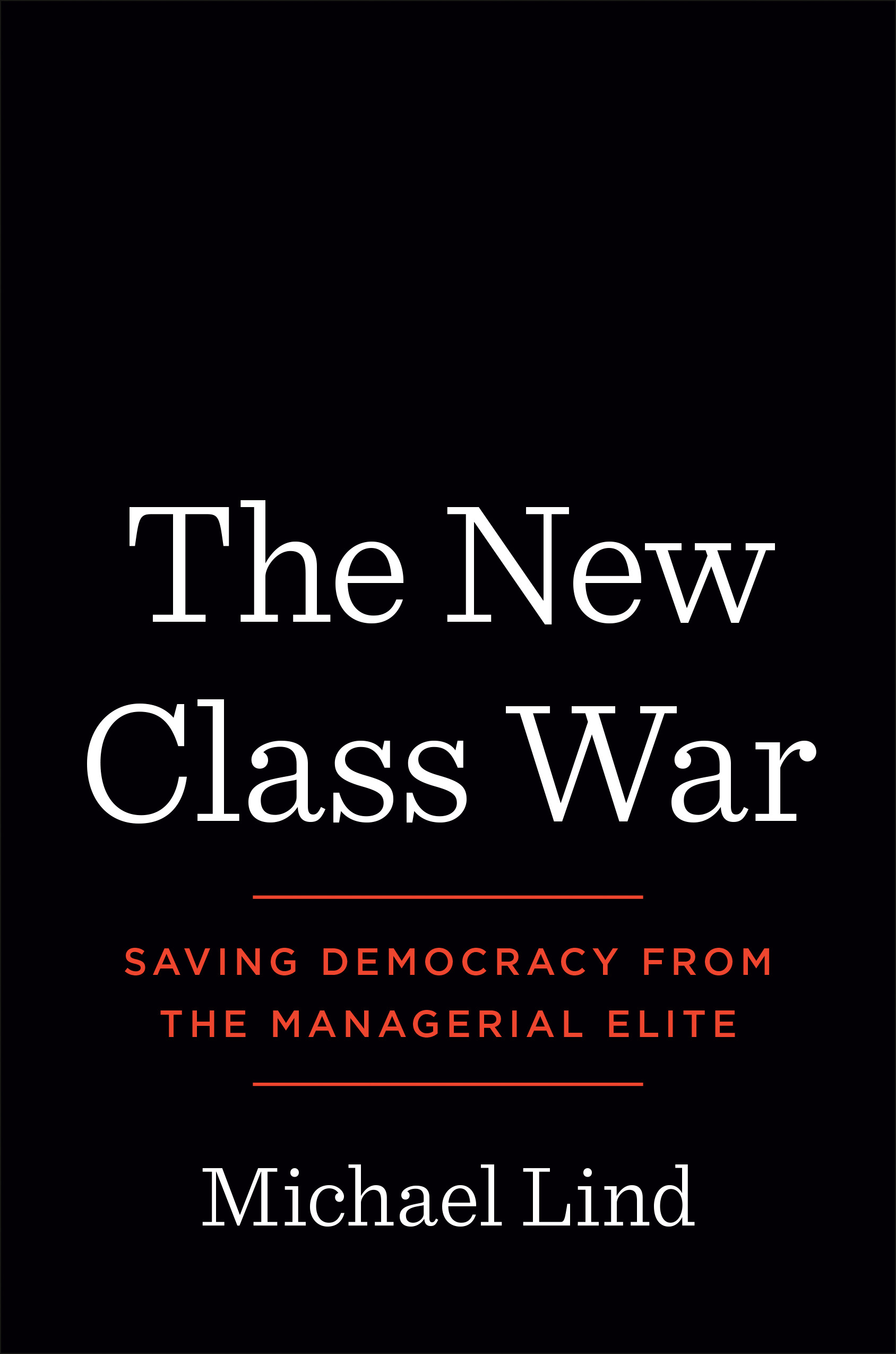
The New Class War In both Europe and North America, populist movements have shattered existing party systems and thrown governments into turmoil. The embattled establishment claims that these populist insurgencies seek to overthrow liberal democracy. The truth is no less alarming but is more complex: Western democracies are being torn apart by a new class war. In this controversial and groundbreaking new analysis, Michael Lind, one of America’s leading thinkers, debunks the idea that the insurgencies are primarily the result of bigotry, traces how the breakdown of mid-century class compromises between business and labor led to the conflict, and reveals the real battle lines. On one side is the managerial overclass—the university-credentialed elite that clusters in high-income hubs and dominates government, the economy and the culture. On the other side is the working class of the low-density heartlands—mostly, but not exclusively, native and white. The two classes clash over immigration, trade, the environment, and social values, and the managerial class has had the upper hand. As a result of the half-century decline of the institutions that once empowered the working class, power has shifted to the institutions the overclass controls: corporations, executive and judicial branches, universities, and the media. The class war can resolve in one of three ways: • The triumph of the overclass, resulting in a high-tech caste system. • The empowerment of populist, resulting in no constructive reforms • A class compromise that provides the working class with real power Lind argues that Western democracies must incorporate working-class majorities of all races, ethnicities, and creeds into decision making in politics, the economy, and culture. Only this class compromise can avert a never-ending cycle of clashes between oligarchs and populists and save democracy. POLITICAL SCIENCE,Political Ideologies,Nationalism & Patriotism
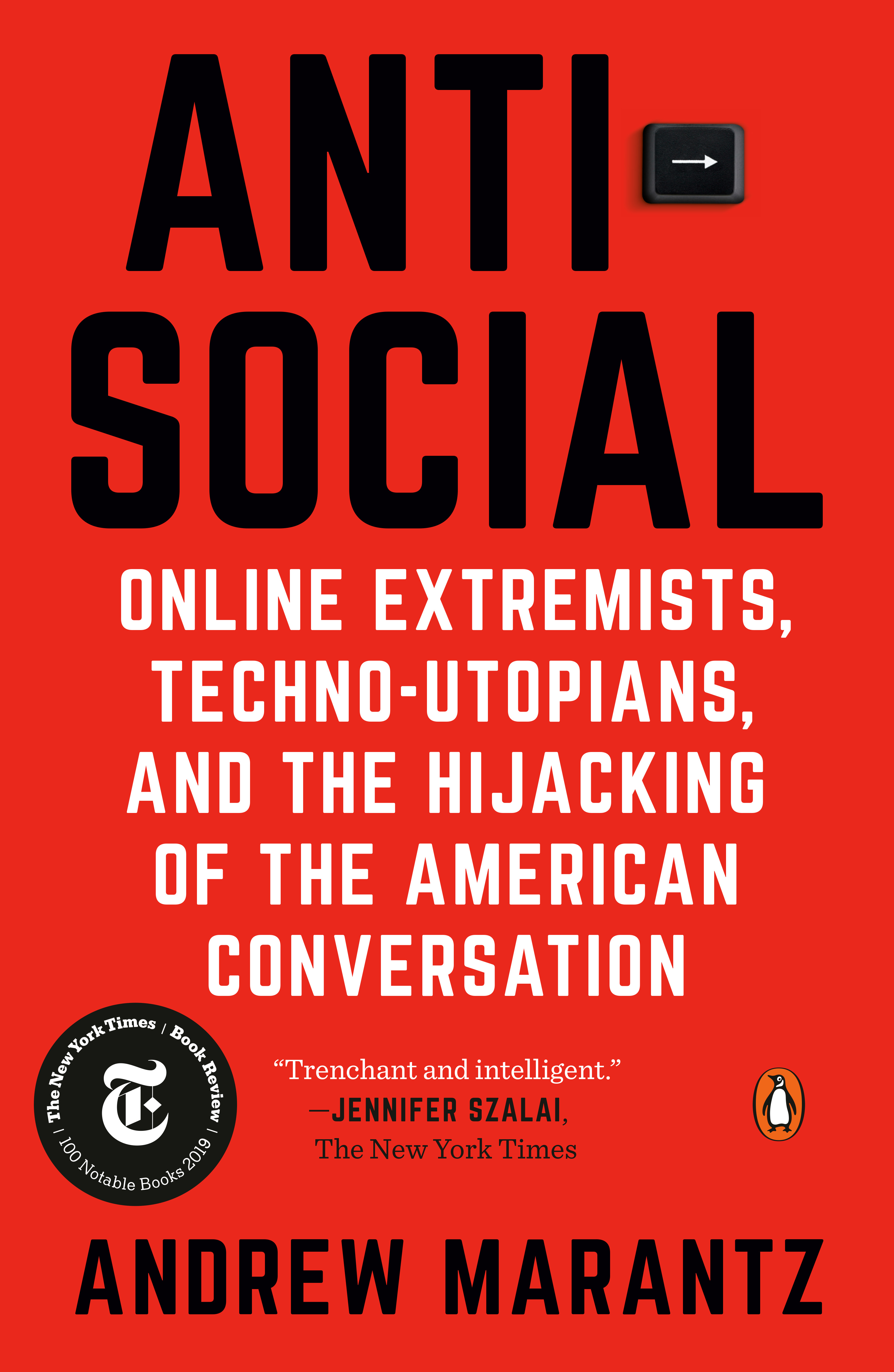
Antisocial "Trenchant and intelligent." --The New York Times As seen/heard on NPR, New Yorker Radio Hour, The New York Book Review Podcast, PBS Newshour, CNBC, and more. A New York Times Book Review Editors' Choice A New York Times Notable Book of 2019 From a rising star at The New Yorker, a deeply immersive chronicle of how the optimistic entrepreneurs of Silicon Valley set out to create a free and democratic internet--and how the cynical propagandists of the alt-right exploited that freedom to propel the extreme into the mainstream. For several years, Andrew Marantz, a New Yorker staff writer, has been embedded in two worlds. The first is the world of social-media entrepreneurs, who, acting out of naïvete and reckless ambition, upended all traditional means of receiving and transmitting information. The second is the world of the people he calls "the gate crashers"--the conspiracists, white supremacists, and nihilist trolls who have become experts at using social media to advance their corrosive agenda. Antisocial ranges broadly--from the first mass-printed books to the trending hashtags of the present; from secret gatherings of neo-Fascists to the White House press briefing room--and traces how the unthinkable becomes thinkable, and then how it becomes reality. Combining the keen narrative detail of Bill Buford's Among the Thugs and the sweep of George Packer's The Unwinding, Antisocial reveals how the boundaries between technology, media, and politics have been erased, resulting in a deeply broken informational landscape--the landscape in which we all now live. Marantz shows how alienated young people are led down the rabbit hole of online radicalization, and how fringe ideas spread--from anonymous corners of social media to cable TV to the President's Twitter feed. Marantz also sits with the creators of social media as they start to reckon with the forces they've unleashed. Will they be able to solve the communication crisis they helped bring about, or are their interventions too little too late? POLITICAL SCIENCE,Political Ideologies,Nationalism & Patriotism

Return of the Strong Gods "'Return of the Strong Gods,'...is a thoughtful contribution to American political debate. It is incisively written and full of modern observations. Mr. Reno explains, better than any book I can remember, the present-day progressive's paranoid fear of fascism and neurotic determination to ferret out racism where none exists." —The Wall Street Journal After the staggering slaughter of back-to-back world wars, the West embraced the ideal of the “open society.†The promise: By liberating ourselves from the old attachments to nation, clan, and religion that had fueled centuries of violence, we could build a prosperous world without borders, freed from dogmas and managed by experts. But the populism and nationalism that are upending politics in America and Europe are a sign that after three generations, the postwar consensus is breaking down. With compelling insight, R. R. Reno argues that we are witnessing the return of the “strong godsâ€â€”the powerful loyalties that bind men to their homeland and to one another. Reacting to the calamitous first half of the twentieth century, our political, cultural, and financial elites promoted open borders, open markets, and open minds. But this never-ending project of openness has hardened into a set of anti-dogmatic dogmas which destroy the social solidarity rooted in family, faith, and nation. While they worry about the return of fascism, our societies are dissolving. But man will not tolerate social dissolution indefinitely. He longs to be part of a “weâ€â€”the fruit of shared loves—which gives his life meaning. The strong gods will return, Reno warns, in one form or another. Our task is to attend to those that, appealing to our reason as well as our hearts, inspire the best of our traditions. Otherwise, we shall invite the darker gods whose return our open society was intended to forestall. POLITICAL SCIENCE,Political Ideologies,Nationalism & Patriotism

The MAGA Doctrine NEW YORK TIMES BESTSELLER. The movement that brought Donald Trump to the White House has better ideas than the old right or the new left. It’s time that the rest of America started listening. The Tea Party began as a protest for patriots who feared Big Government. President Trump has become a hero for patriots who are against Big Everything. Fed up with Silicon Valley, the media, liberal higher education, the military-industrial complex, Twitter mobs, swamp monsters, Big Pharma, out-of-control prosecutors, and gun-grabbing fascists, ordinary Americans miss the days when America cared about rule of the people, by the people, and for the people. Remember when you didn’t feel bombarded on all sides by coastal billionaires and their government stooges? The MAGA Doctrine urges an overdue restoration of self-rule by a populace long taken for granted by its rulers. Turning Point USA founder and social media superstar Charlie Kirk explains once and for all why a New York real estate magnate found an audience among young conservatives all over the country. Trump and his allies are working to protect all the small things that both parties dismissed: local businesses, families, churches, and the rights of the individual. Kirk explains why it took a reality TV superstar to see past the sclerotic and power-hungry institutions, from the United Nations and Google to Harvard and Viacom, working to crush real America. The Trump Doctrine is all about giving you a say in the future of America and a hand in making it happen. As the mainstream media keep churning out lies about the “real reasons†behind the new conservative agenda, Charlie Kirk’s The MAGA Doctrine is a powerful reminder of the true narrative of freedom and greatness that swept Donald Trump to the presidency. POLITICAL SCIENCE,Political Ideologies,Nationalism & Patriotism
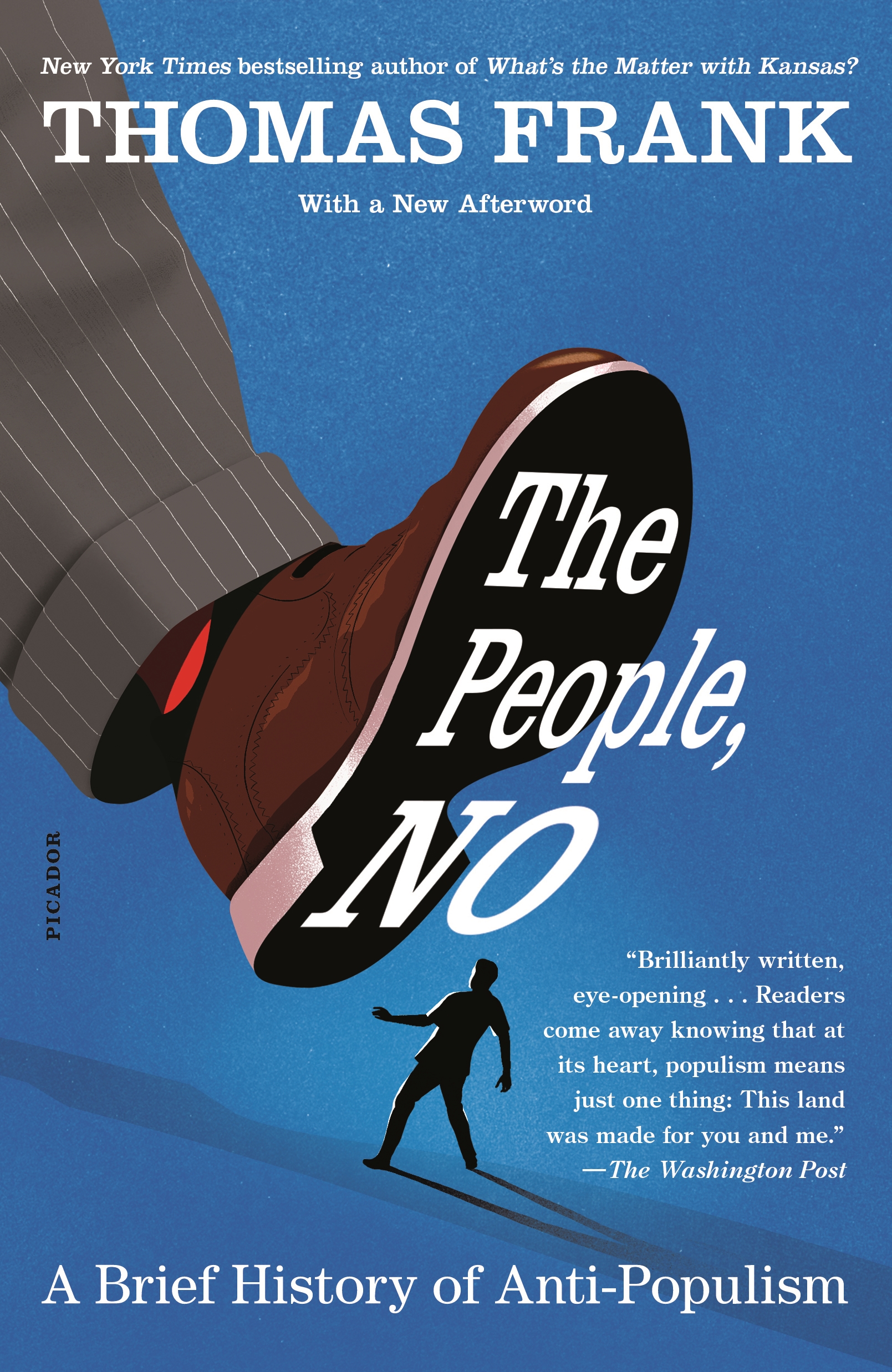
The People, No From the prophetic author of the now-classic What’s the Matter with Kansas? and Listen, Liberal, an eye-opening account of populism, the most important—and misunderstood—movement of our time. Rarely does a work of history contain startling implications for the present, but in The People, No Thomas Frank pulls off that explosive effect by showing us that everything we think we know about populism is wrong. Today “populism†is seen as a frightening thing, a term pundits use to describe the racist philosophy of Donald Trump and European extremists. But this is a mistake. The real story of populism is an account of enlightenment and liberation; it is the story of American democracy itself, of its ever-widening promise of a decent life for all. Taking us from the tumultuous 1890s, when the radical left-wing Populist Party—the biggest mass movement in American history—fought Gilded Age plutocrats to the reformers’ great triumphs under Franklin Roosevelt and Harry Truman, Frank reminds us how much we owe to the populist ethos. Frank also shows that elitist groups have reliably detested populism, lashing out at working-class concerns. The anti-populist vituperations by the Washington centrists of today are only the latest expression. Frank pummels the elites, revisits the movement’s provocative politics, and declares true populism to be the language of promise and optimism. The People, No is a ringing affirmation of a movement that, Frank shows us, is not the problem of our times, but the solution for what ails us. POLITICAL SCIENCE,Political Ideologies,Nationalism & Patriotism
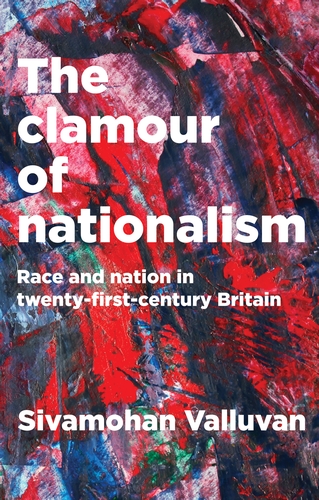
The clamour of nationalism Nationalism has reasserted itself today as the political force of our times, remaking European politics wherever one looks. Britain is no exception, and in the midst of Brexit, it has even become a vanguard of nationalism’s confident return to the mainstream. Intellectual attempts to account for nationalism’s resurgence have however floundered. Desperately trying to read nationalism through one overarching cause – as capitalist crisis, as cultural backlash, or as social media led anti-Establishment politics – these accounts have proven woefully inadequate. This book argues that the only way to understand nationalism is through nationalism itself. To understand it as the key force of modernity that calls upon all existing ideological traditions in asserting its appeal: whether it is liberal, conservative, neoliberal or left-wing. This ideological clamour that characterises today’s British nationalism requires both recognition and theorisation. A meaningful understanding of new nationalism must reckon with the ideological range animating it and the deeply hostile aversion to different racial minorities that pervades its respective ideologies. Drawing on a variety of cultural and political themes – ranging from Corbyn’s dithering, the cult of Churchillism, the neoliberal fixation with a ‘point-system’ immigration policy, the muscular secularism of Richard Dawkins and friends, fears that the white working class have ‘become black’, and even simply the strange appeal of Harry Potter and Game of Thrones – this book provides a dazzling but always detailed study of how nationalism is the politics of today only because it is a politics of everything. POLITICAL SCIENCE,Political Ideologies,Nationalism & Patriotism
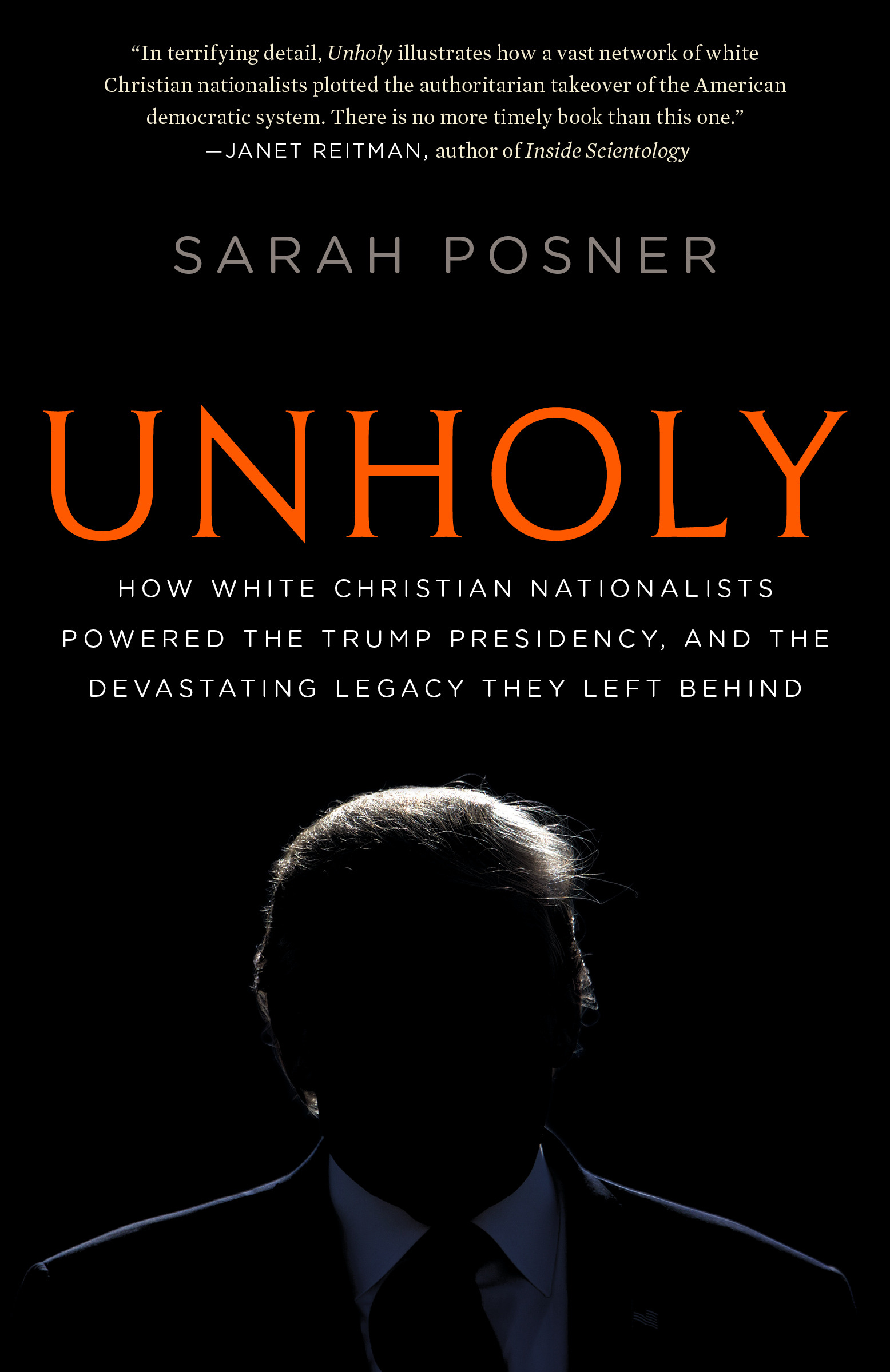
Unholy “In terrifying detail, Unholy illustrates how a vast network of white Christian nationalists plotted the authoritarian takeover of the American democratic system. For anyone wondering what a second Trump administration might bring, there is no more timely book than this one.”—Janet Reitman, author of Inside Scientology Why did so many evangelicals turn out to vote for Donald Trump, a serial philanderer with questionable conservative credentials who seems to defy Christian values with his every utterance? To a reporter like Sarah Posner, who has been covering the religious right for decades, the answer turns out to be far more intuitive than one might think. In this taut inquiry, Posner digs deep into the radical history of the religious right to reveal how issues of race and xenophobia have always been at the movement’s core, and how religion often cloaked anxieties about perceived threats to a white, Christian America. Fueled by an antidemocratic impulse, and united by this narrative of reverse victimization, the religious right and the alt-right support a common agenda–and are actively using the erosion of democratic norms to roll back civil rights advances, stock the judiciary with hard-right judges, defang and deregulate federal agencies, and undermine the credibility of the free press. Increasingly, this formidable bloc is also forging ties with European far right groups, giving momentum to a truly global movement. Revelatory and engrossing, Unholy offers a deeper understanding of the ideological underpinnings and forces influencing the course of Republican politics. This is a book that must be read by anyone who cares about the future of American democracy. POLITICAL SCIENCE,Political Ideologies,Nationalism & Patriotism

Patriotic Dissent This incendiary work by Danny Sjursen is a personal cry from the heart by a once model U.S. Army officer and West Point graduate who became a military dissenter while still on active duty. Set against the backdrop of the terror wars of the last two decades, Sjursen asks whether there is a proper space for patriotism that renounces entitled exceptionalism and narcissistic jingoism. A burgeoning believer and neoconservative, Sjursen calls for a critical exploration of our allegiances, and suggests a path to a new, more complex notion of patriotism. Equal parts somber and idealistic, this is a story about what it means to be an American in the midst of perpetual war, and what the future of patriotism might look like. POLITICAL SCIENCE,Political Ideologies,Nationalism & Patriotism
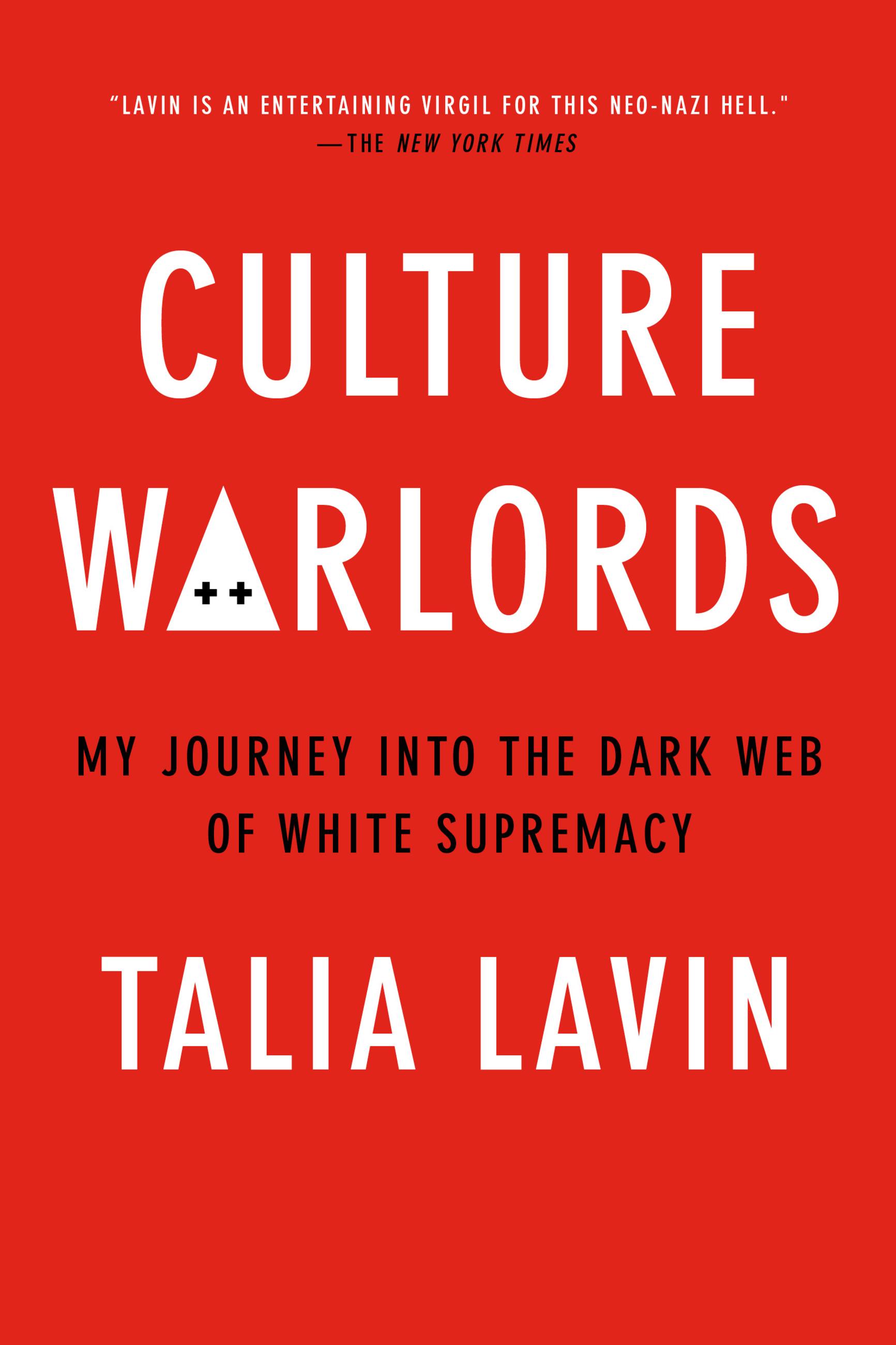
Culture Warlords A HARROWING JOURNEY INTO THE HEART OF WHITE SUPREMACY Talia Lavin is every skinhead's worst nightmare: a loud and unapologetic Jewish woman, acerbic, smart, and profoundly antiracist, with the investigative chops to expose the tactics and ideologies of online hatemongers. Culture Warlords is the story of how Lavin, a frequent target of extremist trolls (including those at Fox News), dove into a byzantine online culture of hate and learned the intricacies of how white supremacy proliferates online. Within these pages, she reveals the extremists hiding in plain sight online: Incels. White nationalists. White supremacists. National Socialists. Proud Boys. Christian extremists. In order to showcase them in their natural habitat, Talia assumes a range of identities, going undercover as a blonde Nazi babe, a forlorn incel, and a violent Aryan femme fatale. Along the way, she discovers a whites-only dating site geared toward racists looking for love, a disturbing extremist YouTube channel run by a fourteen-year-old girl with over 800,000 followers, the everyday heroes of the antifascist movement, and much more. By combining compelling stories chock-full of catfishing and gate-crashing with her own in-depth, gut-wrenching research, she also turns the lens of anti-Semitism, racism, and white power back on itself in an attempt to dismantle and decimate the online hate movement from within. Shocking, humorous, and merciless in equal measure, Culture Warlords explores some of the vilest subcultures on the Web-and shows us how we can fight back. POLITICAL SCIENCE,Political Ideologies,Nationalism & Patriotism

Reflections on the Extreme Right in Western Europe, 1990–2008 During the last three decades or so there has been a significant growth of extreme right voter support, in Europe and elsewhere in the world. The chapters in this book look at an earlier period before most of this increase. Comprising eight previously published articles or book chapters and two hitherto unpublished studies, this book gives extended accounts of the major extreme-right political parties or movements in a number of west European countries, looking both at their antecedents and also at their their support and significance in the 1980s and early 1990s. The countries covered in detail are France, the Federal Republic of Germany (old and new regions), the Netherlands, Belgium, Switzerland, and Austria. During the last three decades some earlier parties of the extreme right in these west European countries have disappeared into oblivion, to be superseded by replacements; others have survived and flourished. Given the date when most of these chapters were written, they are now to be regarded as contributions to a modern history about the status and relevance of the respective parties or movements. The book also includes an introductory essay that discusses issues arising from the disputed labelling terminology used to describe such parties and identifies themes that feature in the more recent literature about the subsequent and current state of the extreme right in Europe. The book will be of particular interest to researchers on the contemporary politics of the extreme-right in Europe, as well as being a valuable resource for those teaching courses on this topic or on general political sociology. POLITICAL SCIENCE,Political Ideologies,Nationalism & Patriotism

Authoritarian Nightmare How did America end up with a leader who acts so crudely and despotically, and counter to our democratic principles? Why do his followers stick with him, even when he acts against their own interests? To fully understand, John Dean, a man with a history of standing up to autocratic presidents, joined with Bob Altemeyer, a professor of psychology with a unique area of expertise: Authoritarianism. Relying on social science findings and psychological diagnostic tools (such as the "Power Mad Scale" and the "Con Man Scale"), as well as research and analysis from the Monmouth University Polling Institute (one of America's most respected public opinion research foundations), the authors provide us with an eye-opening understanding of the Trump phenomenon — and how we may be able to stop it. POLITICAL SCIENCE,Political Ideologies,Nationalism & Patriotism
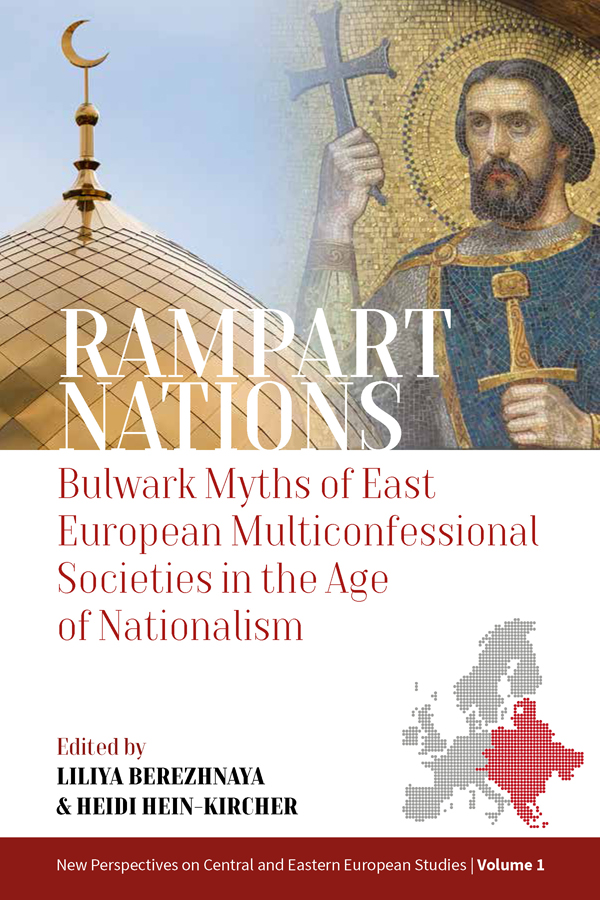
Rampart Nations The “bulwark†or antemurale myth—whereby a region is imagined as a defensive barrier against a dangerous Other—has been a persistent strand in the development of Eastern European nationalisms. While historical studies of the topic have typically focused on clashes and overlaps between sociocultural and religious formations, Rampart Nations delves deeper to uncover the mutual transfers and multi-sided national and interconfessional conflicts that helped to spread bulwark myths through Europe’s eastern periphery over several centuries. Ranging from art history to theology to political science, this volume offers new ways of understanding the political, social, and religious forces that continue to shape identity in Eastern Europe. POLITICAL SCIENCE,Political Ideologies,Nationalism & Patriotism

Twilight of the Merkel Era Elections always have consequences, but the 2017 Bundestag election in Germany proved particularly consequential. With political upheaval across the globe—notably in Britain and the USA—it was vital to European and global order that Germany remain stable. And it did through the re-election of Angela Merkel as chancellor, now in her fourth term. Just under the surface, however, instability is mounting—exemplified by the entry of the right-wing Alternative for Germany (AfD) as the largest opposition party, the decline of the Social Democrats, the ever-restive Bavarians, and the growing factionalism within the Christian Democratic Union as the Merkel era comes to an end. Paying special attention to the rise of the AfD, this volume delves into the campaign, leading political figures, the structure of the electorate, the state of the parties, the media environment, coalition negotiations, and policy impacts. POLITICAL SCIENCE,Political Ideologies,Nationalism & Patriotism
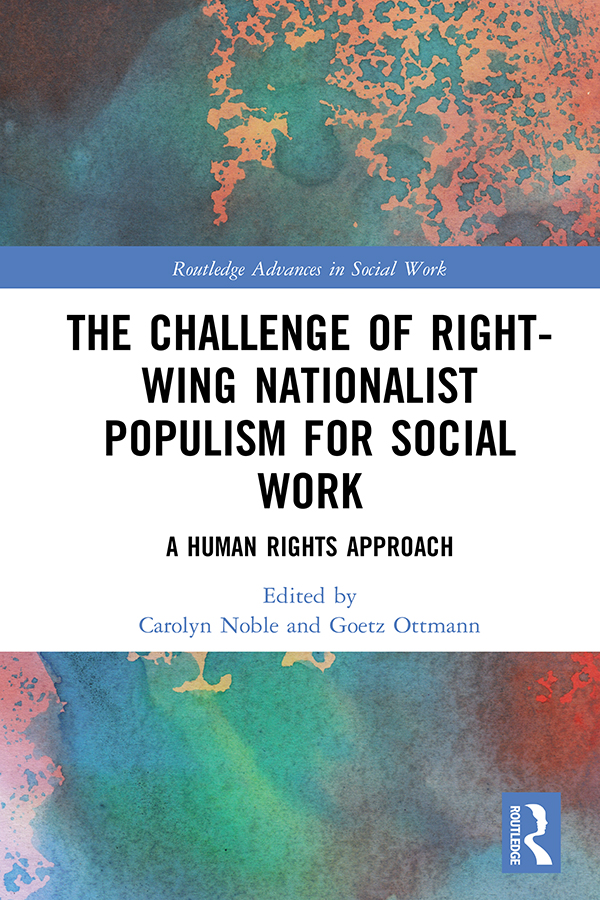
The Challenge of Right-wing Nationalist Populism for Social Work Right-wing nationalist populism poses direct attacks on social tolerance, human rights discourse, political debates, the survival of the welfare state and its universal services, impacting on the roles of social work. This book demonstrates how right-wing nationalist populism can and must be countered. Using case studies from around the world, this book shows how a revitalised radical social work where community organisation, building alliances, trade union commitment and social action can be used as political forces to speak up against discrimination and hate in accordance with human rights, social justice, and social work values. The rise of national populism signals that now is the time for social work to forge and reforge such networks and create links with civil society and challenge right-wing populist policies wherever they manifest themselves. It will be of interest to all social work students, practitioners and academics, particularly those working on critical and radical social work, green social work, anti-oppressive practice and community development. POLITICAL SCIENCE,Political Ideologies,Nationalism & Patriotism

The Populist Challenge During the last decade and a half a new political party family, the extreme Right-wing populist (ERP) parties, has established itself in a variety of West European democracies. These parties represent a monist politics based on ethnic nationalism and xenophobia as well as an opposition against the 'political establishment'. Being the prototypic ERP party, the French Front National (FN) has been a model for ERP parties emerging elsewhere in Western Europe. This study presents a theoretically based explanation that combines the macro and the micro-level, as well as the political supply and the demand-side. More specifically, this study shows that it is necessary to consider both opportunity structures, created by demand and supply-side factors, as well as the ability of the FN to take advantage of the available opportunities. Of particular interest is the author's analysis of the sociology and attitudes of the FN-voters. POLITICAL SCIENCE,Political Ideologies,Nationalism & Patriotism

Rules for Radicals First published in 1971, Rules for Radicals is Saul Alinsky's impassioned counsel to young radicals on how to effect constructive social change and know “the difference between being a realistic radical and being a rhetorical one.” Written in the midst of radical political developments whose direction Alinsky was one of the first to question, this volume exhibits his style at its best. Like Thomas Paine before him, Alinsky was able to combine, both in his person and his writing, the intensity of political engagement with an absolute insistence on rational political discourse and adherence to the American democratic tradition. POLITICAL SCIENCE,Political Ideologies,Radicalism
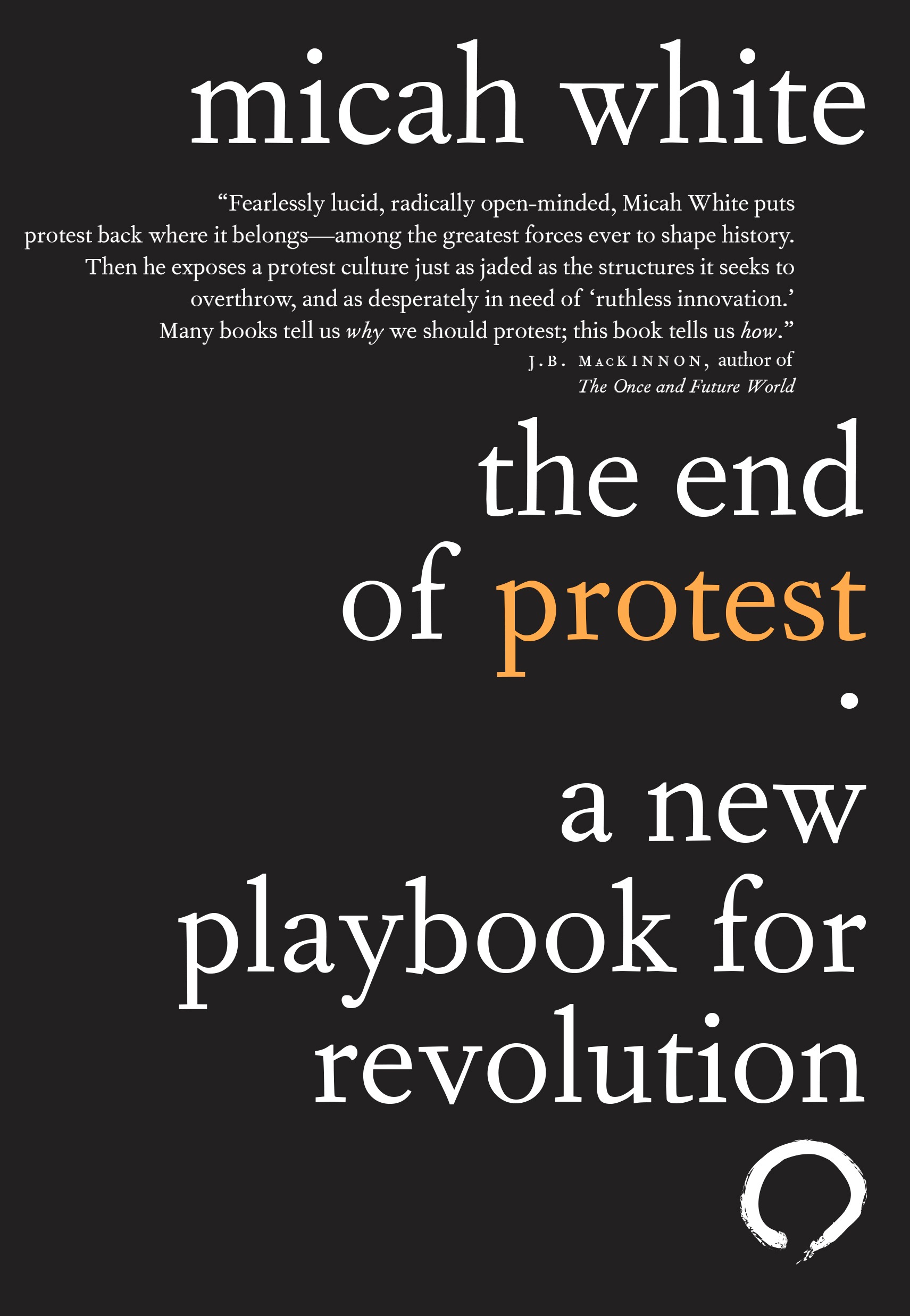
The End of Protest Is protest broken? Micah White, co-creator of Occupy Wall Street, thinks so. Disruptive tactics have failed to halt the rise of Donald Trump. Movements ranging from Black Lives Matter to environmentalism are leaving activists frustrated. Meanwhile, recent years have witnessed the largest protests in human history. Yet these mass mobilizations no longer change society. Now activism is at a crossroads: innovation or irrelevance. In The End of Protest Micah White heralds the future of activism. Drawing on his unique experience with Occupy Wall Street, a contagious protest that spread to eighty-two countries, White articulates a unified theory of revolution and eight principles of tactical innovation that are destined to catalyze the next generation of social movements. Despite global challenges—catastrophic climate change, economic collapse and the decline of democracy—White finds reason for optimism: the end of protest inaugurates a new era of social change. On the horizon are increasingly sophisticated movements that will emerge in a bid to challenge elections, govern cities and reorient the way we live. Activists will reshape society by forming a global political party capable of winning elections worldwide. In this provocative playbook, White offers three bold, revolutionary scenarios for harnessing the creativity of people from across the political spectrum. He also shows how social movements are created and how they spread, how materialism limits contemporary activism, and why we must re-conceive protest in timelines of centuries, not days. Rigorous, original and compelling, The End of Protest is an exhilarating vision of an all-encompassing revolution of revolution. POLITICAL SCIENCE,Political Ideologies,Radicalism

States of Discipline Examines contemporary capitalism by bringing together original case studies that analyze the transformation of neoliberal governance into increasingly non-democratic, coercive and disciplining forms of statecraft POLITICAL SCIENCE,Political Ideologies,Radicalism

Engineers of Jihad A groundbreaking investigation into why so many Islamic radicals are engineers The violent actions of a few extremists can alter the course of history, yet there persists a yawning gap between the potential impact of these individuals and what we understand about them. In Engineers of Jihad, Diego Gambetta and Steffen Hertog uncover two unexpected facts, which they imaginatively leverage to narrow that gap: they find that a disproportionate share of Islamist radicals come from an engineering background, and that Islamist and right-wing extremism have more in common than either does with left-wing extremism, in which engineers are absent while social scientists and humanities students are prominent. Searching for an explanation, they tackle four general questions about extremism: Under which socioeconomic conditions do people join extremist groups? Does the profile of extremists reflect how they self-select into extremism or how groups recruit them? Does ideology matter in sorting who joins which group? Lastly, is there a mindset susceptible to certain types of extremism? Using rigorous methods and several new datasets, they explain the link between educational discipline and type of radicalism by looking at two key factors: the social mobility (or lack thereof) for engineers in the Muslim world, and a particular mindset seeking order and hierarchy that is found more frequently among engineers. Engineers' presence in some extremist groups and not others, the authors argue, is a proxy for individual traits that may account for the much larger question of selective recruitment to radical activism. Opening up markedly new perspectives on the motivations of political violence, Engineers of Jihad yields unexpected answers about the nature and emergence of extremism. POLITICAL SCIENCE,Political Ideologies,Radicalism
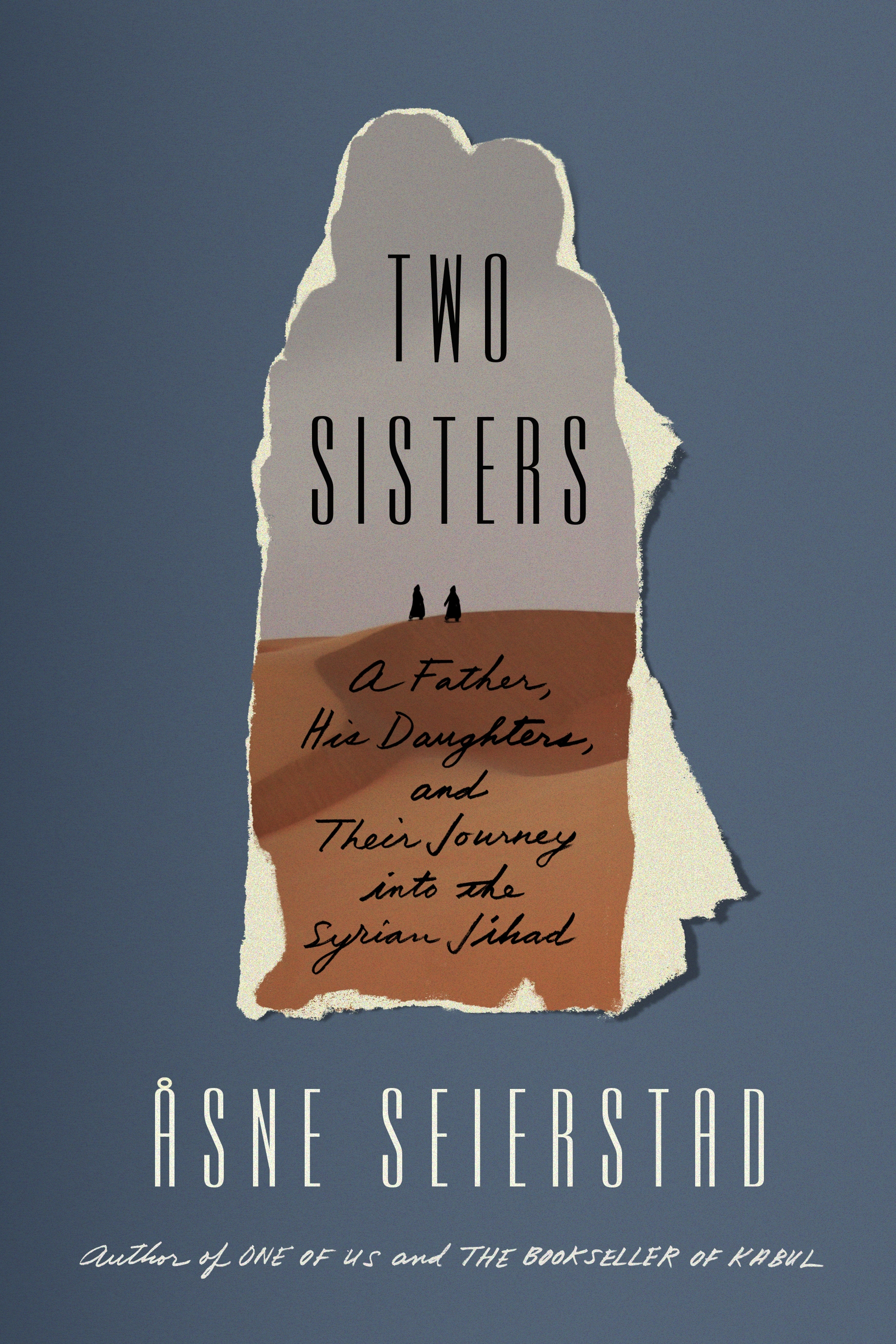
Two Sisters The riveting true story of two sisters’ journey to the Islamic State and the father who tries to bring them home Two Sisters, by the international bestselling author Åsne Seierstad, tells the unforgettable story of a family divided by faith. Sadiq and Sara, Somali immigrants raising a family in Norway, one day discover that their teenage daughters, Leila and Ayan, have vanished—and are en route to Syria to aid the Islamic State. Seierstad’s riveting account traces the sisters’ journey from secular, social democratic Norway to the front lines of the war in Syria, and follows Sadiq’s harrowing attempt to find them. Employing the same mastery of narrative suspense she brought to The Bookseller of Kabul and One of Us, Seierstad puts the problem of radicalization into painfully human terms, using instant messages and other primary sources to reconstruct a family’s crisis from the inside. Eventually, she takes us into the hellscape of the Syrian civil war, as Sadiq risks his life in pursuit of his daughters, refusing to let them disappear into the maelstrom—even after they marry ISIS fighters. Two Sisters is a relentless thriller and a feat of reporting with profound lessons about belief, extremism, and the meaning of devotion. POLITICAL SCIENCE,Political Ideologies,Radicalism

Everything You Love Will Burn The dark story of the shocking resurgence of white supremacist and nationalist groups, and their path to political power Six years ago, Vegas Tenold embedded himself among the members of three of America's most ideologically extreme white nationalist groups-the KKK, the National Socialist Movement, and the Traditionalist Workers Party. At the time, these groups were part of a disorganized counterculture that felt far from the mainstream. But since then, all that has changed. Racially-motivated violence has been on open display at rallies in Charlottesville, Berkeley, Pikesville, Phoenix, and Boston. Membership in white nationalist organizations is rising, and national politicians, including the president, are validating their perceived grievances. Everything You Love Will Burn offers a terrifying, sobering inside look at these newly empowered movements, from their conventions to backroom meetings with Republican operatives. Tenold introduces us to neo-Nazis in Brooklyn; a millennial Klanswoman in Tennessee; and a rising star in the movement, nicknamed the "Little Fÿ by the Southern Poverty Law Center, who understands political power and is organizing a grand coalition of far-right groups to bring them into the mainstream. Everything You Love Will Burn takes readers to the dark, paranoid underbelly of America, a world in which the white race is under threat and the enemy is everywhere. POLITICAL SCIENCE,Political Ideologies,Radicalism

Panic Attack Robby Soave investigates millennial activism in the age of Trump, and profiles the full spectrum of major and minor groups on left and right, in Panic Attack. POLITICAL SCIENCE,Political Ideologies,Radicalism
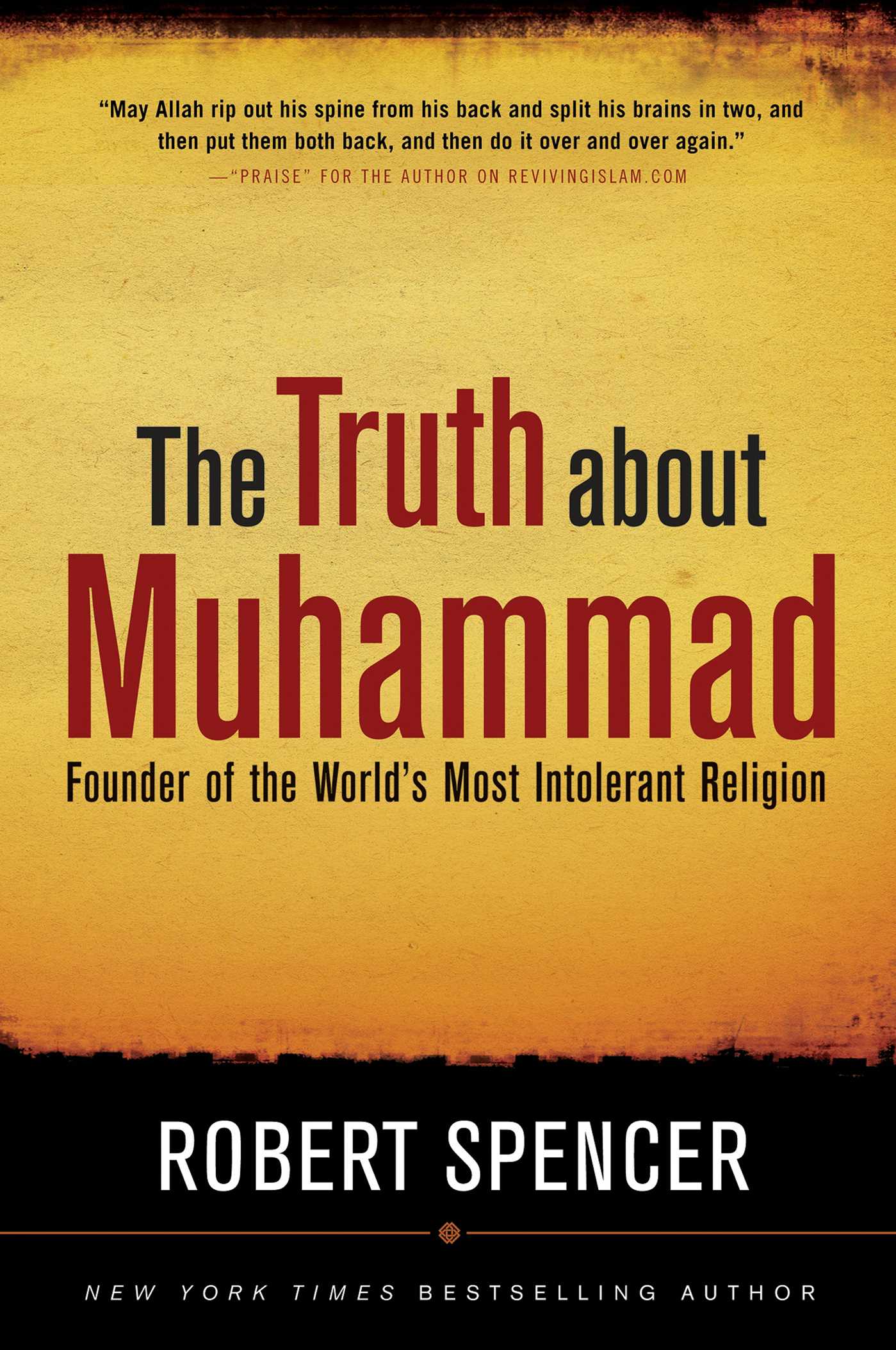
The Truth About Muhammad Muhammad: a frank look at his influential (and violent) life and teachingsIn The Truth about Muhammad, New York Times bestselling author and Islam expert Robert Spencer offers an honest and telling portrait of the founder of Islam-perhaps the first such portrait in half a century-unbounded by fear and political correctness, unflinching, and willing to face the hard facts about Muhammad's life that continue to affect our world today. From Muhammad's first "revelation" from Allah (which filled him with terror that he was demonpossessed) to his deathbed (from which he called down curses upon Jews and Christians), it's all here-told with extensive documentation from the sources that Muslims themselves consider most reliable about Muhammad. Spencer details Muhammad's development from a preacher of hellfire and damnation into a political and military leader who expanded his rule by force of arms, promising his warriors luridly physical delights in Paradise if they were killed in his cause. He explains how the Qur'an's teaching on warfare against unbelievers developed-with constant war to establish the hegemony of Islamic law as the last stage. Spencer also gives the truth about Muhammad's convenient "revelations" justifying his own licentiousness; his joy in the brutal murders of his enemies; and above all, his clear marching orders to his followers to convert non-Muslims to Islam-or force them to live as inferiors under Islamic rule. In The Truth about Muhammad, you'll learn - The truth about Muhammad's multiple marriages (including one to a nine-year-old) - How Muhammad set legal standards that make it virtually impossible to prove rape in Islamic countries - How Muhammad's example justifies jihad and terrorism - The real "Satanic verses" incident (not the Salman Rushdie version) that remains a scandal to Muslims - How Muhammad's faulty knowledge of Judaism and Christianity has influenced Islamic theology--and colored Muslim relations with Jews and Christians to this day. Recognizing the true nature of Islam, Spencer argues, is essential for judging the prospects for largescale Islamic reform, the effective prosecution of the War on Terror, the democracy project in Afghanistan and Iraq, and immigration and border control to protect the United States from terrorism. All of which makes it crucial for every citizen (and policymaker) who loves freedom to read and ponder The Truth about Muhammad POLITICAL SCIENCE,Political Ideologies,Radicalism

The Politically Incorrect Guide to Jihad A book to challenge the status quo, spark a debate, and get people talking about the issues and questions we face as a country! POLITICAL SCIENCE,Political Ideologies,Radicalism

The Complete Infidel's Guide to Iran Our Most Dangerous Enemy Think it's ISIS? Think again. Iran is the terrorist powerhouse of the world—made all the more dangerous by the disastrous "nuclear deal" that restricts Iran's nuclear ambitions hardly at all. The Iranian government is an open enemy of the United States—and of anyone who dissents from Shia Islam. Iran confronts U.S. Navy ships in the Persian Gulf "on a near daily basis." It executes more of its citizens than any other nation. It is a country torn by hypocrisy—lectured by mullahs, and with brutally enforced Islamic religious laws, but rife with alcoholism. Once America's ally, Iran now claims leadership of the global jihad, and the ayatollahs' aim is nothing less than world conquest for Islam. In his extraordinary new book, The Complete Infidel's Guide to Iran, New York Times bestselling author Robert Spencer reveals: How the Iranian "nuclear deal" is sheer capitulation to the mullahs, allowing Iran to inspect its own facilities and pursue nuclear weapons Iran's long-standing support for terrorists—including shocking evidence that Iran helped plan the 9/11 attacks Why Iran wants nuclear weapons—clue: it's not about deterrence American diplomatic folly—why the Obama administration has grossly underestimated the Iranian threat A new grand strategy: how Iran's Shi'ite terrorism might be contained and its threat to the United States reduced The Islamic Republic is already at war with America. If we refuse to recognize that fact, we are only falling prey to the mullahs' campaign of duplicity. The Complete Infidel's Guide to Iran exposes the true nature of the threat, lays out what America must do to defeat it, and gives you all the information you need about America's least understood yet potentially most lethal foe. POLITICAL SCIENCE,Political Ideologies,Radicalism

The Complete Infidel's Guide to the Koran The Complete Infidel’s Guide to the Koran exposes how the Koran incites hatred and violence and is anti-democratic, anti-freedom, and intolerant of any other ideology. Stripping out the obsolete debate, The Complete Infidel’s Guide to the Koran focuses on the decrees toward Jews and Christians, how they were viewed by Muhammad, what “the infidels†have done wrong and what the Koran has in store for them. The Complete Infidel’s Guide to the Koran is the essential primer to comprehending one of the most cryptic and misunderstood religious texts. Robert Spencer sheds light on the violence inherent in the Koran and reveals the frightening implications for the War on Terror, the U.S. and the world. In The Complete Infidel’s Guide to the Koran you will learn: The true meaning of celebrated and seemingly benign verses, such as “Strive in the way of Allah†and “Persecution is worse than slaughter†How the Koran sanctions domestic abuse, honor killing, and murder How the Koran not only discourages Infidels from reading it, but mandates that they don’t even touch it Why Obama, Clinton, and others are dangerously close to supporting a multiculturalism based on an ideology that aims to destroy the principles America holds dear POLITICAL SCIENCE,Political Ideologies,Radicalism

The Complete Infidel's Guide to ISIS ISIS rocketed onto the world stage seemingly out of nowhere, beheading American hostages, bulldozing international borders, routing the American-trained Iraqi army, and carving out a new state that rules eight million people and a territory larger than the United Kingdom. But who are they? Where did ISIS come from, and how did they rise to power in so little time? What is driving them—and how can they be stopped? New York Times bestselling author Robert Spencer reveals the blood-drenched history and inner workings of the Islamic State—its military conquests, how it is financing its expansion, and the ideology that is driving its success. As Spencer reveals, the Islamic State has taken the first steps on the path to becoming a serious world power—steps that Osama bin Laden and al-Qaeda dreamed of but were afraid to take. The Complete Infidel's Guide to ISIS is your one-stop easy reference for all you need to know about ISIS—and how "infidels" can stop its reign of terror. POLITICAL SCIENCE,Political Ideologies,Radicalism

A Religion of Peace? Christianity or Islam: which is the real "religion of peace"? Almost any liberal pundit will tell you that there's a religion bent on destroying our Constitution, stripping us of our liberties, and imposing religious rule on the U.S. And that religion is . . .Christianity! About Islam, however, the Left is silent--except to claim a moral equivalence between the two: if Islam has terrorists today, that's nothing compared to the Crusades, inquisitions, and religious wars in Christianity's past. But is this true? Are conservative Christians really more of a threat to free societies than Islamic jihadists? Is the Bible really "just as violent" as the Qur'an? Is Christianity's history really as bloodstained as Islam's? In Religion of Peace? Why Christianity Is and Islam Isn't, New York Times bestselling author Robert Spencer not only refutes such charges, but also explains why Americans and Europeans must regain an appreciation of our Christian heritage if we ever hope to defeat Islamic supremacism. POLITICAL SCIENCE,Political Ideologies,Radicalism

The Muhammad Code The Muhammad Code tells the story of how Mohammad invented jihad and demanded that it conquer the earth. POLITICAL SCIENCE,Political Ideologies,Radicalism

Defeating ISIS A New York Times bestseller! This reference shows how to understand the history and tactics of the global terror group ISISand how to use that knowledge to defeat it. ISISthe Islamic State of Iraq and Syriahas taken on the mantle of being the single most dangerous terrorist threat to global security since al-Qaeda. In Defeating ISIS, internationally renowned intelligence veteran, author, and counterterrorism expert Malcolm Nance gives an insider’s view to explain the origins of this occult group, its violent propaganda, and how it spreads its ideology throughout the Middle East and to disaffected youth deep in the heart of the Western world. Most importantly, Defeating ISIS gives an amply illustrated, step-by-step analysis of the street-level tactics the group has employed in assaults against fortified targets, in urban combat, and during terrorist operations such as those in Paris during the November 13 attacks. As much as ISIS is a threat to Western targets and regional stability in the Middle East, Nance describes not only its true danger as a heretical death cult that seeks to wrest control of Islam through young ideologues and redefine Islam as a fight to the death against all comers, but also how to defeat it. Defeating ISIS is the first highly detailed and fully illustrated look into the organization by one of the world’s foremost authorities in counterterrorism. 100 color illustrations, 100 black-and-white illustrations, maps throughout POLITICAL SCIENCE,Political Ideologies,Radicalism
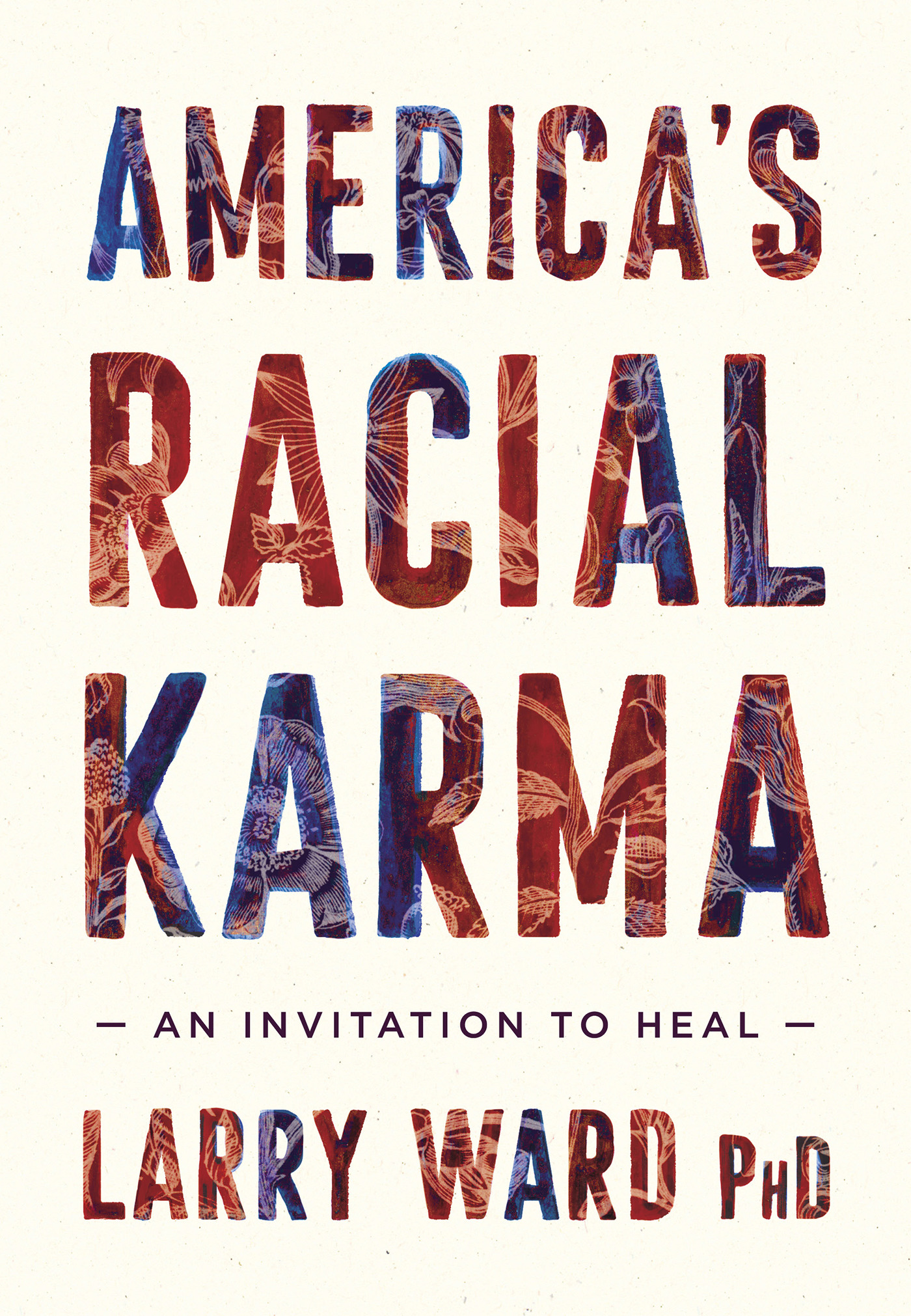
America's Racial Karma Immediate, illuminating, and hopeful: this is the key set of talks given by leading Zen Buddhist teacher Larry Ward, PhD, on breaking America's cycle of racial trauma. "I am a drop in the ocean, but I'm also the ocean. I'm a drop in America, but I'm also America. Every pain, every confusion, every good and every bad and ugly of America is in me. And as I transform myself and heal and take care of myself, I'm very conscious that I'm healing and transforming and taking care of America. I say this for American cynics, but this is also true globally. It's for real." So says Zen Buddhist teacher Dr. Larry Ward. Shot at by the police as an 11-year-old child for playing baseball in the wrong spot, as an adult, Larry Ward experienced the trauma of having his home firebombed by racists. At Plum Village Monastery in France, the home in exile of his teacher, Vietnamese peace activist and Zen teacher Thich Nhat Hanh, Dr. Ward found a way to heal. In these short reflective essays, he offers his insights on the effects of racial constructs and answers the question: how do we free ourselves from our repeated cycles of anger, denial, bitterness, pain, fear, violence? Larry Ward looks at the causes and conditions that have led us to our current state and finds, hidden in the crisis, a profound opportunity to reinvent what it means to be a human being. This is an invitation to transform America's racial karma. POLITICAL SCIENCE,Political Ideologies,Radicalism
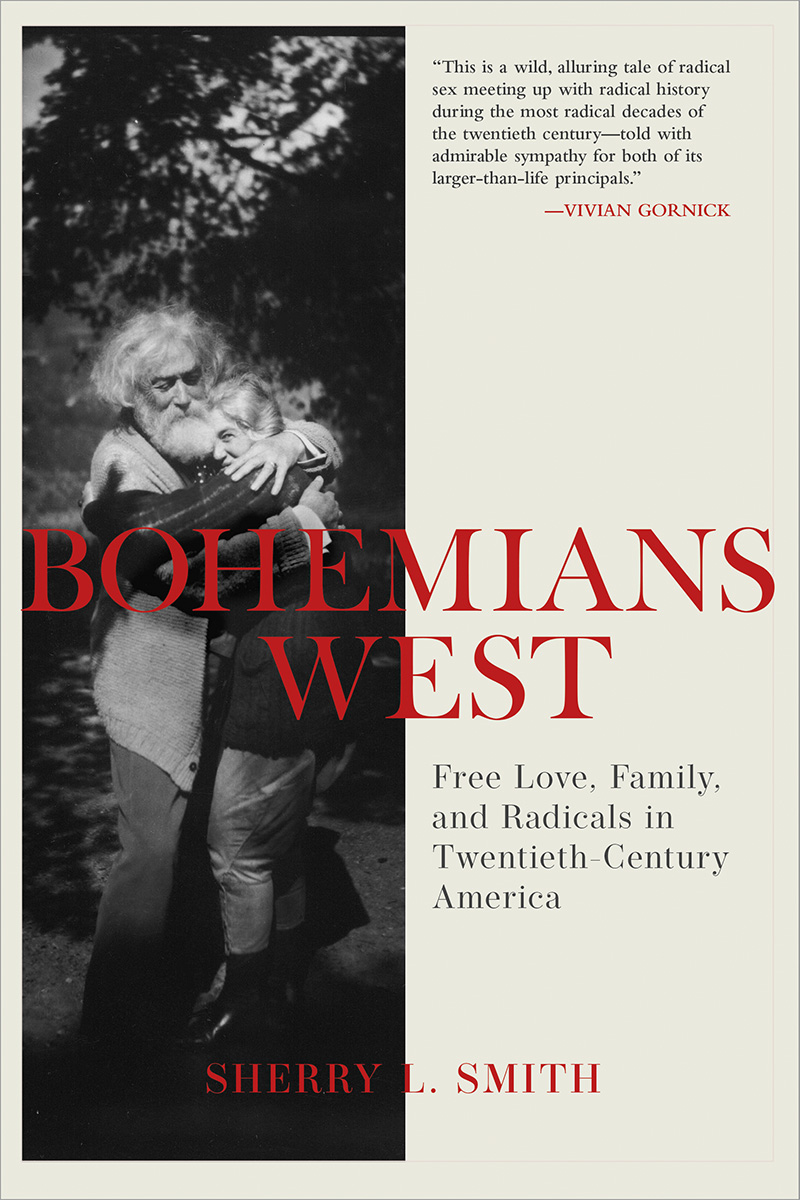
Bohemians West The opening years of the twentieth century saw a grand cast of radicals and reformers fighting for a new America, seeking change not only in labor picket lines and at women’s suffrage rallies but also in homes and bedrooms. In the thick of this heady milieu were Sara Bard Field and Charles Erskine Scott Wood, two aspiring poets whose love story uncovers a potent emotional world underneath this transformative time. Self-declared pioneers in free love, Sara and Erskine exchanged hundreds of letters that charted a new kind of romantic relationship, and their personal pursuits frequently came into contact with their deeply engaged political lives. As Sara’s star rose in the suffrage movement, culminating in her making a cross-country car trip in 1915 and gathering hundreds of thousands of signatures for a petition to Congress, she began to ask questions about her own power in her relationship with Erskine. Charting a passionate and tumultuous relationship that spanned decades, Bohemians West offers a deeply personal look at a dynamic period in American history. POLITICAL SCIENCE,Political Ideologies,Radicalism
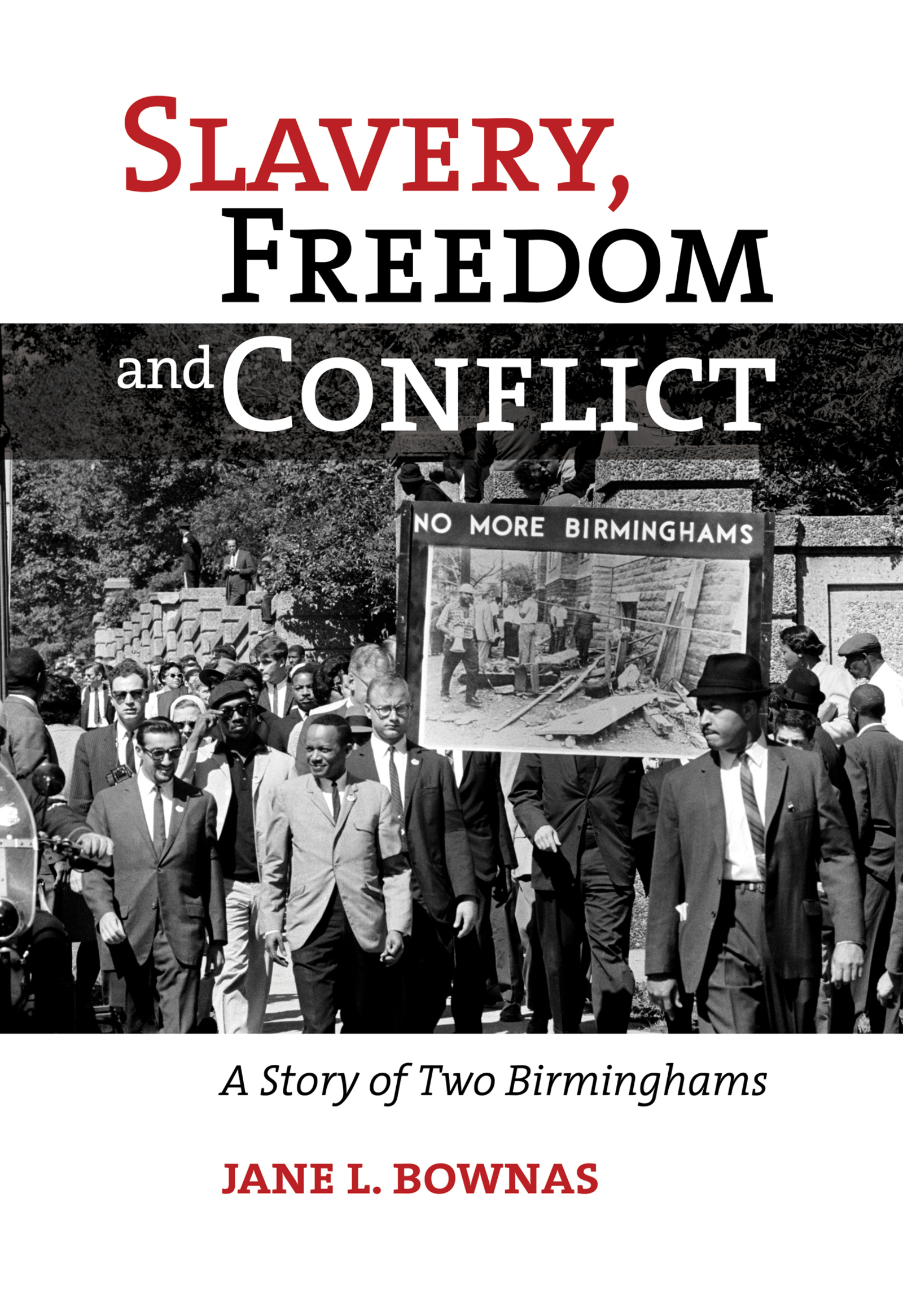
Slavery, Freedom and Conflict A Story of Two Birminghams examines the roles played by two cities and the areas in which they are situated in the long history of people of African origin and their ancestors who were taken into slavery, experienced a phoney freedom and subsequently experienced racism, segregation and violence. From the eighteenth century the industrial city of Birmingham in England was involved in the manufacture of guns used in the African slave trade and then later, in the production and export of the steam engines used on the sugar plantations in the West Indies. In northern Alabama, on land where another industrial city of the same name would later develop, African slaves worked on cotton plantations owned by planters who would later make their fortunes by selling the mineral rich land. Abolitionists in Birmingham UK, and in the Southern States fought against much opposition to achieve freedom for the slaves. But this was often a phoney freedom: for example, under an ‘apprenticeship' system in Jamaica people endured conditions often worse than under slavery, and in Alabama they endured hard labour in the development of the new industrial city and under the ‘Convict Lease ‘system. Slavery, Freedom and Conflict follows the life path of descendants of slaves into the twentieth century, the difficulties experienced by West Indian immigrants in Birmingham UK, the segregation laws imposed in Birmingham, Alabama and the US Civil Rights movement which followed. Later in the century, riots occurring in Handsworth (Birmingham UK), the election of a far-right, racist politician in nearby Smethwick and the infamous speech of Enoch Powell indicated that, as in Birmingham, Alabama many black people were still suffering from the iniquities of the slave trade inflicted upon their ancestors more than two hundred years previously. This book is essential reading for all those with an interest in the history of slavery, and in the local history of the West Midlands of England and the Northern counties of Alabama. POLITICAL SCIENCE,Political Ideologies,Radicalism

Welcome to the Rebellion What does it mean that our most popular modern myth, Star Wars, is a radical left story about fighting corporate authoritarianism? POLITICAL SCIENCE,Political Ideologies,Radicalism

My Friend the Fanatic A nation once synonymous with tolerance, Indonesia, the fourth-most populated country in the world and its most populous Muslim country, now finds itself in the midst of a profound shift toward radical Islam. Sadanand Dhume, a Princeton-educated Indian atheist with a fondness for literary fiction and an interest in economic development, travels across Indonesia to find out how a society goes from broad inclusiveness to outspoken intolerance in the space of a generation. His traveling companion is Harry Nurdi, a young Islamist who hero-worships the late Osama bin Laden and sympathizes with the Taliban. Their travels span mosques and discotheques, prison cells and dormitories, sacred volcanoes and temple ruins. Over time, they forge an uneasy friendship that offers a firsthand look into the crucible of radical Islam’s future. With a new preface by the author detailing what has happened in Indonesia since the book’s initial publication, My Friend the Fanatic is the story of an alternately disturbing, amusing, and poignant journey that illuminates one of the most pressing issues of our time. POLITICAL SCIENCE,Political Ideologies,Radicalism

Pirates, Terrorists, and Warlords Pirates, warlords, guerillas, criminal organizations, drug cartels, apocalyptic religious extremists, police agencies, terrorists: these are classic insurgents whose past, present, and future is dissected in this important book. Contributing writers including Martha Crenshaw, T. X. Hammes, Russell Howard, Gene Cristy, Yosef Kuperwasser, and academics from Naval War College, Marine Corps War College, and Stanford University, explore important insurgency-related issues such as domestic terrorism, globalization of armed groups, children on the battlefield, religious influence on armed fights, and more. This rich anthology offers scholars and citizens a new way to think about national and international securityas it stands today, and its future. POLITICAL SCIENCE,Political Ideologies,Radicalism

Picture Perfect We say the camera doesn't lie, but we also know that pictures distort and deceive. In Picture Perfect, Kiku Adatto brilliantly examines the use and abuse of images today. Ranging from family albums to Facebook, political campaigns to popular movies, images of war to pictures of protest. Adatto reveals how the line between the person and the pose, the real and the fake, news and entertainment is increasingly blurred. New technologies make it easier than ever to capture, manipulate, and spread images. But even in the age of the Internet, we still seek authentic pictures and believe in the camera's promise to document, witness, and interpret our lives. POLITICAL SCIENCE,Political Process,Campaigns & Elections
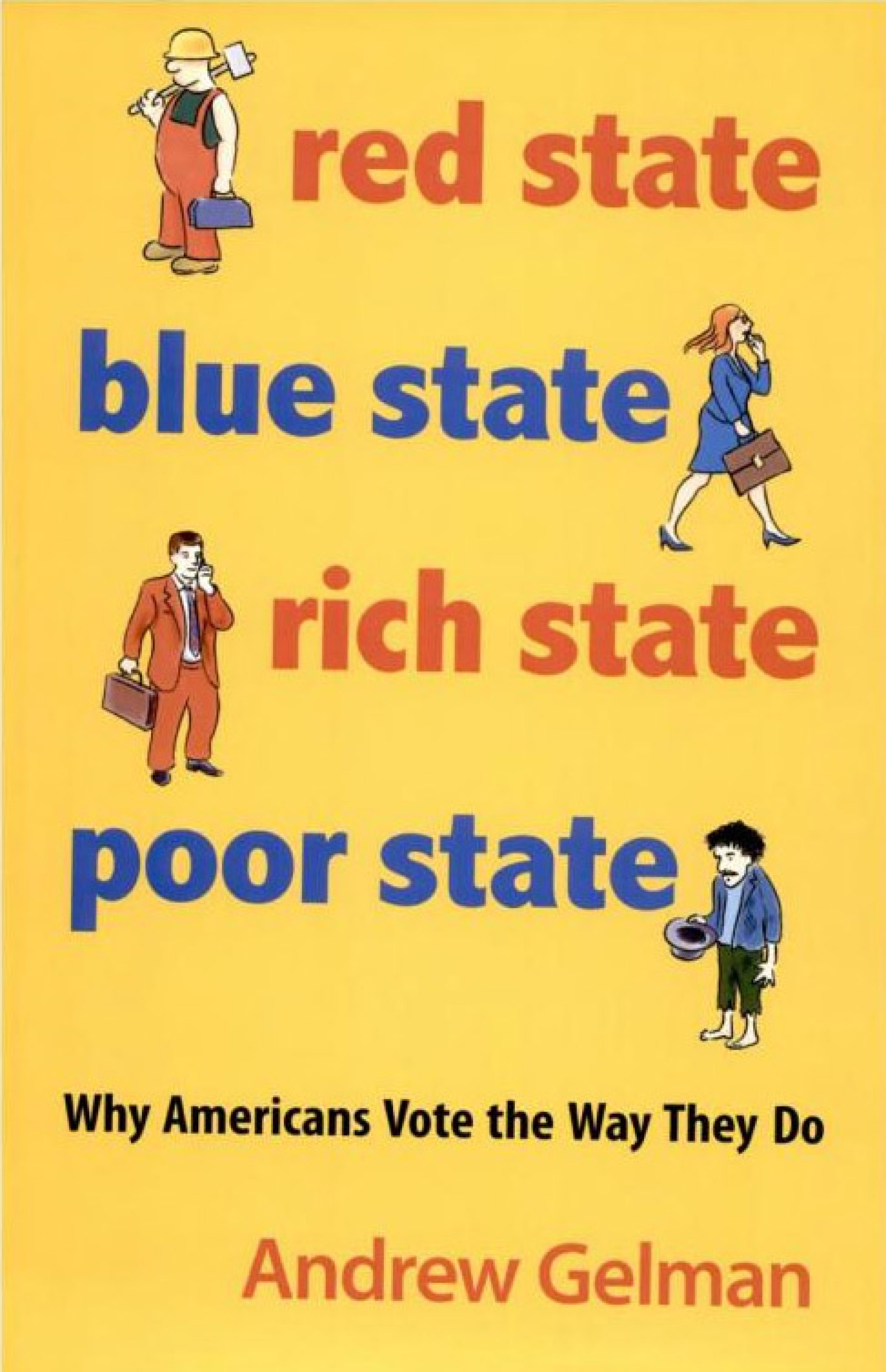
Red State, Blue State, Rich State, Poor State On the night of the 2000 presidential election, Americans watched on television as polling results divided the nation's map into red and blue states. Since then the color divide has become symbolic of a culture war that thrives on stereotypes--pickup-driving red-state Republicans who vote based on God, guns, and gays; and elitist blue-state Democrats woefully out of touch with heartland values. With wit and prodigious number crunching, Andrew Gelman debunks these and other political myths. This expanded edition includes new data and easy-to-read graphics explaining the 2008 election. Red State, Blue State, Rich State, Poor State is a must-read for anyone seeking to make sense of today's fractured political landscape. POLITICAL SCIENCE,Political Process,Campaigns & Elections

Gaming the Vote Our Electoral System is Fundamentally Flawed, But There's a Simple and Fair Solution At least five U.S. presidential elections have been won by the second most popular candidate. The reason was a "spoiler"—a minor candidate who takes enough votes away from the most popular candidate to tip the election to someone else. The spoiler effect is more than a glitch. It is a consequence of one of the most surprising intellectual discoveries of the twentieth century: the "impossibility theorem" of Nobel laureate economist Kenneth Arrow. The impossibility theorem asserts that voting is fundamentally unfair—a finding that has not been lost on today's political consultants. Armed with polls, focus groups, and smear campaigns, political strategists are exploiting the mathematical faults of the simple majority vote. In recent election cycles, this has led to such unlikely tactics as Republicans funding ballot drives for Green spoilers and Democrats paying for right-wing candidates' radio ads. Gaming the Vote shows that there is a solution to the spoiler problem that will satisfy both right and left. A systemcalled range voting, already widely used on the Internet, is the fairest voting method of all, according to computer studies. Despite these findings, range voting remains controversial, and Gaming the Vote assesses the obstacles confronting any attempt to change the American electoral system. The latest of several books by William Poundstone on the theme of how important scientific ideas have affected the real world, Gaming the Vote is a wry exposé of how the political system really works, and a call to action. POLITICAL SCIENCE,Political Process,Campaigns & Elections
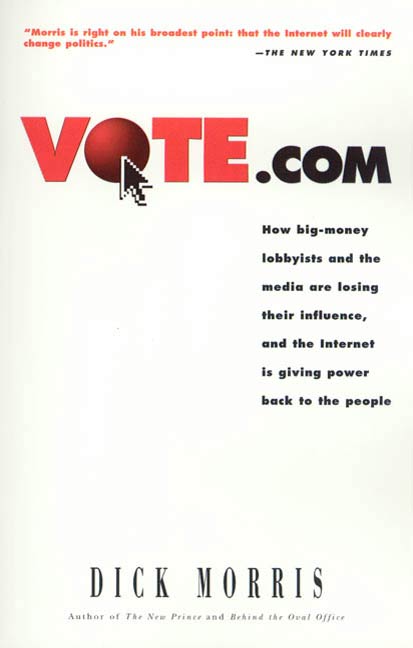
Vote.com As the print and broadcast media-commonly referred to as the Fourth Estate-falters and fails, a new social and political force is rising in power. The Fifth Estate, as Morris has dubbed it, is made up of the rapidly growing number of voters who use Internet technology. This army of younger citizens with easy access to information and a direct link to their representatives heralds a new dawning of democracy, putting political power back into the hands of the people. POLITICAL SCIENCE,Political Process,Campaigns & Elections

The Swing Vote As our country's politicians engage in bitter partisan battles, focused on protecting their own jobs but not on doing the nation's business, and political pundits shout louder and shriller to improve their ratings, it's no wonder that Americans have little faith in their government. But is America as divided as the politicians and talking heads would have us believe? Do half of Americans stand on the right and the other half on the left with a no-man's-land between them? Hardly. Forty percent of all American voters are Independents who occupy the ample political and ideological space in the center. These Americans are anything but divided, and they're being ignored. These Independents make up the largest voting bloc in the nation and have determined the outcome of every election since World War II. Every year their numbers grow, as does the unconscionable disconnect between them and the officials who are supposed to represent them. The Swing Vote: The Untapped Power of Independents tells the story of how our polarized political system is not only misrepresenting America but failing it. Linda Killian looks beyond the polls and the headlines and talks with the frustrated citizens who are raising the alarm about the acute bi-polarity, special interest-influence, and gridlock in Congress, asking why Obama's postpartisan presidency is anything but, and demanding realism, honest negotiation, and a sense of responsibility from their elected officials. Killian paints a vivid portrait of the swing voters around the country and presents a new model that reveals who they are and what they want from their government and elected officials. She also offers a way forward, including solutions for fixing our broken political system. This is not only a timely shot across the bows of both parties but an impassioned call to Independents to bring America back into balance. POLITICAL SCIENCE,Political Process,Campaigns & Elections

Anything for a Vote A revised and updated history of mudslinging, character assassination, and other election strategies from U.S. presidential politics of the past. Covering 225-plus years of smear campaigns, slanderous candidates, and bad behavior in American elections, this comprehensive history is the authoritative tour of political shade-throwing from George Washington to Barack Obama. You might think today’s politicians play rough—but history reveals that dirty tricks are as American as apple pie. Let the name-calling begin! 1836: Congressman Davy Crockett accuses candidate Martin Van Buren of secretly wearing women’s clothing: “He is laced up in corsets!” 1864: Candidate George McClellan describes his opponent, Abraham Lincoln, as “nothing more than a well-meaning baboon!” 1960: Former president Harry Truman advises voters that “if you vote for Richard Nixon, you ought to go to hell!” Full of sleazy and shameless anecdotes from every presidential election in United States history, Anything for a Vote is a valuable reminder that history does repeat itself, lessons can be learned from the past (but usually aren’t), and our most famous presidents are not above reproach when it comes to the dirtiest game of all—political campaigning. POLITICAL SCIENCE,Political Process,Campaigns & Elections

How to Win an Election How to Win an Election is an ancient Roman guide for campaigning that is as up-to-date as tomorrow's headlines. In 64 BC when idealist Marcus Cicero, Rome's greatest orator, ran for consul (the highest office in the Republic), his practical brother Quintus decided he needed some no-nonsense advice on running a successful campaign. What follows in his short letter are timeless bits of political wisdom, from the importance of promising everything to everybody and reminding voters about the sexual scandals of your opponents to being a chameleon, putting on a good show for the masses, and constantly surrounding yourself with rabid supporters. Presented here in a lively and colorful new translation, with the Latin text on facing pages, this unashamedly pragmatic primer on the humble art of personal politicking is dead-on (Cicero won)--and as relevant today as when it was written. A little-known classic in the spirit of Machiavelli's Prince, How to Win an Election is required reading for politicians and everyone who enjoys watching them try to manipulate their way into office. POLITICAL SCIENCE,Political Process,Campaigns & Elections
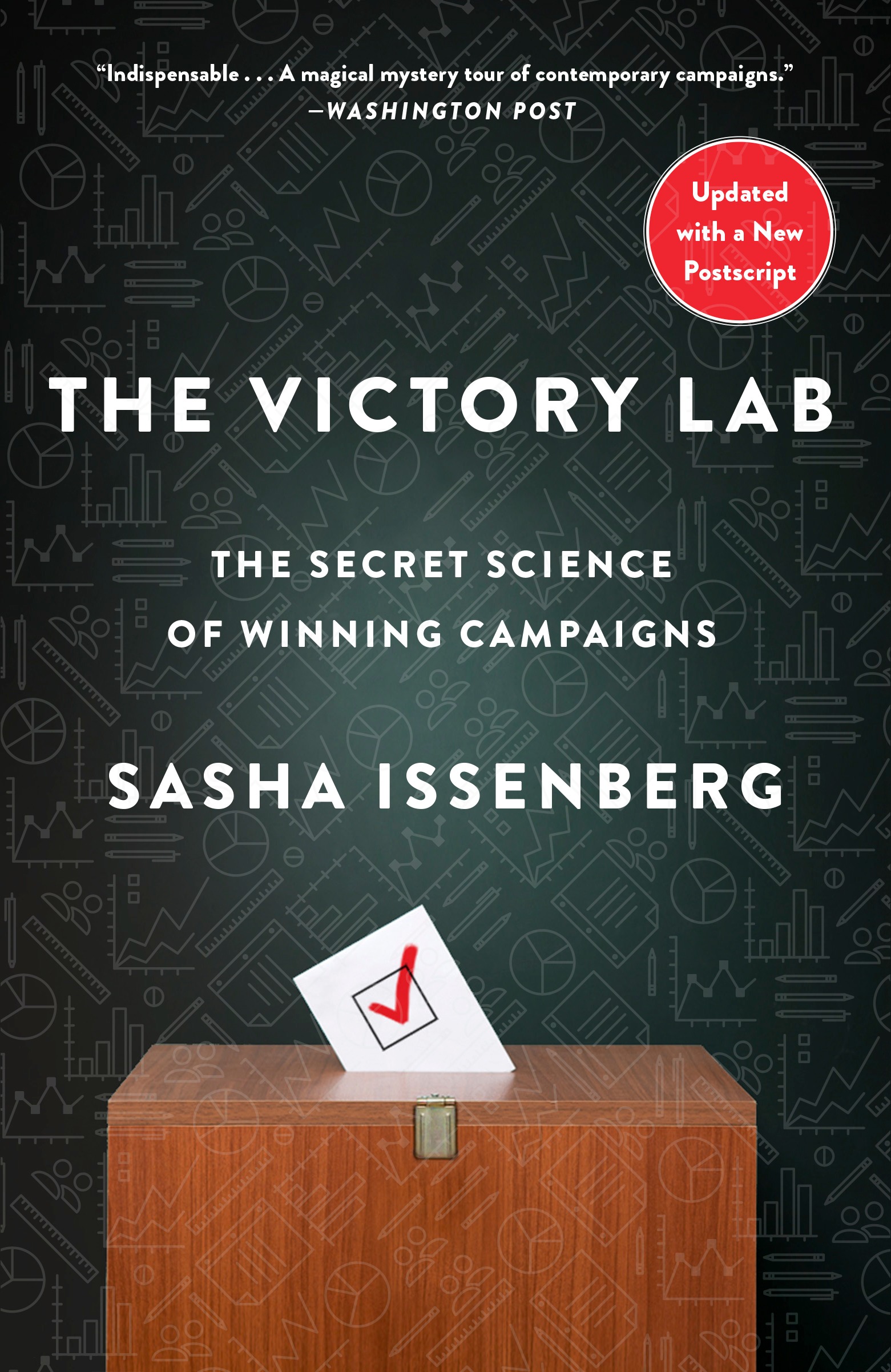
The Victory Lab UPDATED FOR THE 2016 ELECTION The book Politico calls “Moneyball for politics” shows how cutting-edge social science and analytics are reshaping the modern political campaign. Renegade thinkers are crashing the gates of a venerable American institution, shoving aside its so-called wise men and replacing them with a radical new data-driven order. We’ve seen it in sports, and now in The Victory Lab, journalist Sasha Issenberg tells the hidden story of the analytical revolution upending the way political campaigns are run in the 21st century. The Victory Lab follows the academics and maverick operatives rocking the war room and re-engineering a high-stakes industry previously run on little more than gut instinct and outdated assumptions. Armed with research from behavioural psychology and randomized experiments that treat voters as unwitting guinea pigs, the smartest campaigns now believe they know who you will vote for even before you do. Issenberg tracks these fascinating techniques—which include cutting edge persuasion experiments, innovative ways to mobilize voters, heavily researched electioneering methods—and shows how our most important figures, such as Barack Obama and Mitt Romney, are putting them to use with surprising skill and alacrity. Provocative, clear-eyed and energetically reported, The Victory Lab offers iconoclastic insights into political marketing, human decision-making, and the increasing power of analytics. POLITICAL SCIENCE,Political Process,Campaigns & Elections

The Signal and the Noise UPDATED FOR 2020 WITH A NEW PREFACE BY NATE SILVER "One of the more momentous books of the decade."—The New York Times Book Review Nate Silver built an innovative system for predicting baseball performance, predicted the 2008 election within a hair’s breadth, and became a national sensation as a blogger—all by the time he was thirty. He solidified his standing as the nation's foremost political forecaster with his near perfect prediction of the 2012 election. Silver is the founder and editor in chief of the website FiveThirtyEight. Drawing on his own groundbreaking work, Silver examines the world of prediction, investigating how we can distinguish a true signal from a universe of noisy data. Most predictions fail, often at great cost to society, because most of us have a poor understanding of probability and uncertainty. Both experts and laypeople mistake more confident predictions for more accurate ones. But overconfidence is often the reason for failure. If our appreciation of uncertainty improves, our predictions can get better too. This is the “prediction paradox”: The more humility we have about our ability to make predictions, the more successful we can be in planning for the future. In keeping with his own aim to seek truth from data, Silver visits the most successful forecasters in a range of areas, from hurricanes to baseball to global pandemics, from the poker table to the stock market, from Capitol Hill to the NBA. He explains and evaluates how these forecasters think and what bonds they share. What lies behind their success? Are they good—or just lucky? What patterns have they unraveled? And are their forecasts really right? He explores unanticipated commonalities and exposes unexpected juxtapositions. And sometimes, it is not so much how good a prediction is in an absolute sense that matters but how good it is relative to the competition. In other cases, prediction is still a very rudimentary—and dangerous—science. Silver observes that the most accurate forecasters tend to have a superior command of probability, and they tend to be both humble and hardworking. They distinguish the predictable from the unpredictable, and they notice a thousand little details that lead them closer to the truth. Because of their appreciation of probability, they can distinguish the signal from the noise. With everything from the health of the global economy to our ability to fight terrorism dependent on the quality of our predictions, Nate Silver’s insights are an essential read. POLITICAL SCIENCE,Political Process,Campaigns & Elections
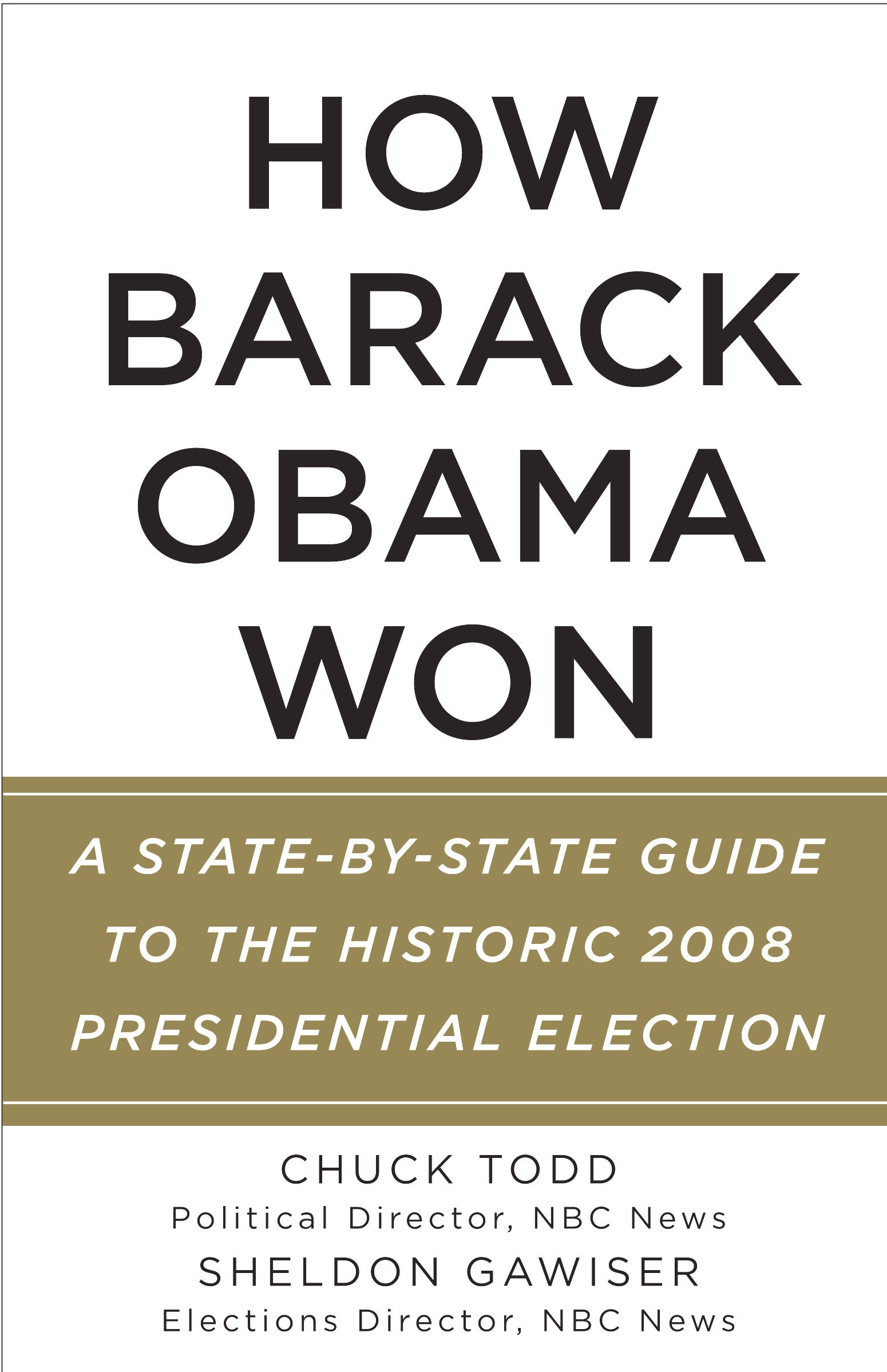
How Barack Obama Won This detailed overview and analysis of the results of Barack Obama’s historic 2008 presidential win gives us the inside state-by-state guide to how Obama achieved his victory, and allows us to see where the country stood four years ago. Although much has changed in the nearly four years since, How Barack Obama Won remains the essential guide to Obama’s electoral strengths and offers important perspective on his 2012 bid. The votes in each state for Obama and McCain are broken down by percentage according to gender, age, race, party, religious affiliation, education, household income, size of city, and according to views about the most important issues (the economy, terrorism, Iraq, energy, healthcare), the future of the economy (worried, not worried) and the war in Iraq (approve, disapprove). POLITICAL SCIENCE,Political Process,Campaigns & Elections
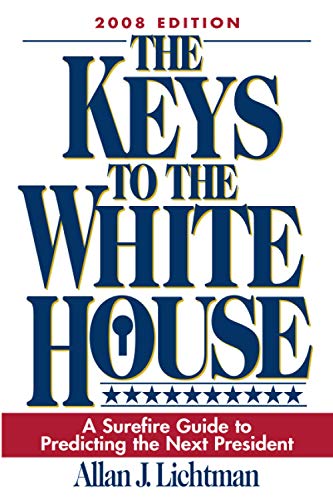
The Keys to the White House Prominent political analyst and historian, Allan J. Lichtman, presents thirteen historical factors, or 'keys,' that have successfully predicted the outcome of presidential elections from 1860 to 2004. POLITICAL SCIENCE,Political Process,Campaigns & Elections
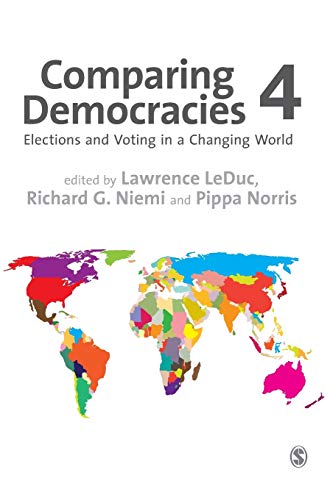
Comparing Democracies Taking a global, comparative look at voting and elections, this Fourth Edition has new chapters on authoritarian elections and regime change, electoral integrity, and voting behaviour POLITICAL SCIENCE,Political Process,Campaigns & Elections

Dark Money NATIONAL BESTSELLER ONE OF THE NEW YORK TIMES 10 BEST BOOKS OF THE YEAR Who are the immensely wealthy right-wing ideologues shaping the fate of America today? From the bestselling author of The Dark Side, an electrifying work of investigative journalism that uncovers the agenda of this powerful group. In her new preface, Jane Mayer discusses the results of the most recent election and Donald Trump's victory, and how, despite much discussion to the contrary, this was a huge victory for the billionaires who have been pouring money in the American political system. Why is America living in an age of profound and widening economic inequality? Why have even modest attempts to address climate change been defeated again and again? Why do hedge-fund billionaires pay a far lower tax rate than middle-class workers? In a riveting and indelible feat of reporting, Jane Mayer illuminates the history of an elite cadre of plutocrats—headed by the Kochs, the Scaifes, the Olins, and the Bradleys—who have bankrolled a systematic plan to fundamentally alter the American political system. Mayer traces a byzantine trail of billions of dollars spent by the network, revealing a staggering conglomeration of think tanks, academic institutions, media groups, courthouses, and government allies that have fallen under their sphere of influence. Drawing from hundreds of exclusive interviews, as well as extensive scrutiny of public records, private papers, and court proceedings, Mayer provides vivid portraits of the secretive figures behind the new American oligarchy and a searing look at the carefully concealed agendas steering the nation. Dark Money is an essential book for anyone who cares about the future of American democracy. National Book Critics Circle Award Finalist LA Times Book Prize FinalistPEN/Jean Stein Book Award FinalistShortlisted for the Lukas Prize POLITICAL SCIENCE,Political Process,Campaigns & Elections

Electoral Violence, Corruption, and Political Order A comprehensive look at how violence has been used to manipulate competitive electoral processes around the world since World War II Throughout their history, political elections have been threatened by conflict, and the use of force has in the past several decades been an integral part of electoral processes in a significant number of contemporary states. However, the study of elections has yet to produce a comprehensive account of electoral violence. Drawing on cross-national data sets together with fourteen detailed case studies from around the world, Electoral Violence, Corruption, and Political Order offers a global comparative analysis of violent electoral practices since the Second World War. Sarah Birch shows that the way power is structured in society largely explains why elections are at risk of violence in some contexts but not in others. Countries with high levels of corruption and weak democratic institutions are especially vulnerable to disruptions of electoral peace. She examines how corrupt actors use violence to back up other forms of electoral manipulation, including vote buying and ballot stuffing. In addition to investigating why electoral violence takes place, Birch considers what can be done to prevent it in the future, arguing that electoral authority and the quality of electoral governance are more important than the formal design of electoral institutions. Delving into a deeply influential aspect of political malpractice, Electoral Violence, Corruption, and Political Order explores the circumstances in which individuals choose to employ violence as an electoral strategy. POLITICAL SCIENCE,Political Process,Campaigns & Elections

Unbelievable NEW YORK TIMES BESTSELLER “Compelling… this book couldn’t be more timely.†– Jill Abramson, New York Times Book Review From the Recipient of the 2017 Walter Cronkite Award for Excellence in Journalism Called "disgraceful," "third-rate," and "not nice" by Donald Trump, NBC News correspondent Katy Tur reported on—and took flak from—the most captivating and volatile presidential candidate in American history. Katy Tur lived out of a suitcase for a year and a half, following Trump around the country, powered by packets of peanut butter and kept clean with dry shampoo. She visited forty states with the candidate, made more than 3,800 live television reports, and tried to endure a gazillion loops of Elton John’s "Tiny Dancer"—a Trump rally playlist staple. From day 1 to day 500, Tur documented Trump’s inconsistencies, fact-checked his falsities, and called him out on his lies. In return, Trump repeatedly singled Tur out. He tried to charm her, intimidate her, and shame her. At one point, he got a crowd so riled up against Tur, Secret Service agents had to walk her to her car. None of it worked. Facts are stubborn. So was Tur. She was part of the first women-led politics team in the history of network news. The Boys on the Bus became the Girls on the Plane. But the circus remained. Through all the long nights, wild scoops, naked chauvinism, dodgy staffers, and fevered debates, no one had a better view than Tur. Unbelievable is her darkly comic, fascinatingly bizarre, and often scary story of how America sent a former reality show host to the White House. It’s also the story of what it was like for Tur to be there as it happened, inside a no-rules world where reporters were spat on, demeaned, and discredited. Tur was a foreign correspondent who came home to her most foreign story of all. Unbelievable is a must-read for anyone who still wakes up and wonders, Is this real life? POLITICAL SCIENCE,Political Process,Campaigns & Elections

Playing with Fire From the host of MSNBC’s The Last Word with Lawrence O'Donnell, an important and enthralling new account of the presidential election that changed everything, the race that created American politics as we know it today The 1968 U.S. Presidential election was the young Lawrence O’Donnell’s political awakening, and in the decades since it has remained one of his abiding fascinations. For years he has deployed one of America’s shrewdest political minds to understanding its dynamics, not just because it is fascinating in itself, but because in it is contained the essence of what makes America different, and how we got to where we are now. Playing With Fire represents O’Donnell’s master class in American electioneering, embedded in the epic human drama of a system, and a country, coming apart at the seams in real time. Nothing went according to the script. LBJ was confident he'd dispatch with Nixon, the GOP frontrunner; Johnson's greatest fear and real nemesis was RFK. But Kennedy and his team, despite their loathing of the president, weren't prepared to challenge their own party’s incumbent. Then, out of nowhere, Eugene McCarthy shocked everyone with his disloyalty and threw his hat in the ring to run against the president and the Vietnam War. A revolution seemed to be taking place, and LBJ, humiliated and bitter, began to look mortal. Then RFK leapt in, LBJ dropped out, and all hell broke loose. Two assassinations and a week of bloody riots in Chicago around the Democratic Convention later, and the old Democratic Party was a smoldering ruin, and, in the last triumph of old machine politics, Hubert Humphrey stood alone in the wreckage. Suddenly Nixon was the frontrunner, having masterfully maintained a smooth façade behind which he feverishly held his party’s right and left wings in the fold, through a succession of ruthless maneuvers to see off George Romney, Nelson Rockefeller, Ronald Reagan, and the great outside threat to his new Southern Strategy, the arch-segregationist George Wallace. But then, amazingly, Humphrey began to close, and so, in late October, Nixon pulled off one of the greatest dirty tricks in American political history, an act that may well meet the statutory definition of treason. The tone was set for Watergate and all else that was to follow, all the way through to today. Playing With Fire is the perfect holiday gift! POLITICAL SCIENCE,Political Process,Campaigns & Elections
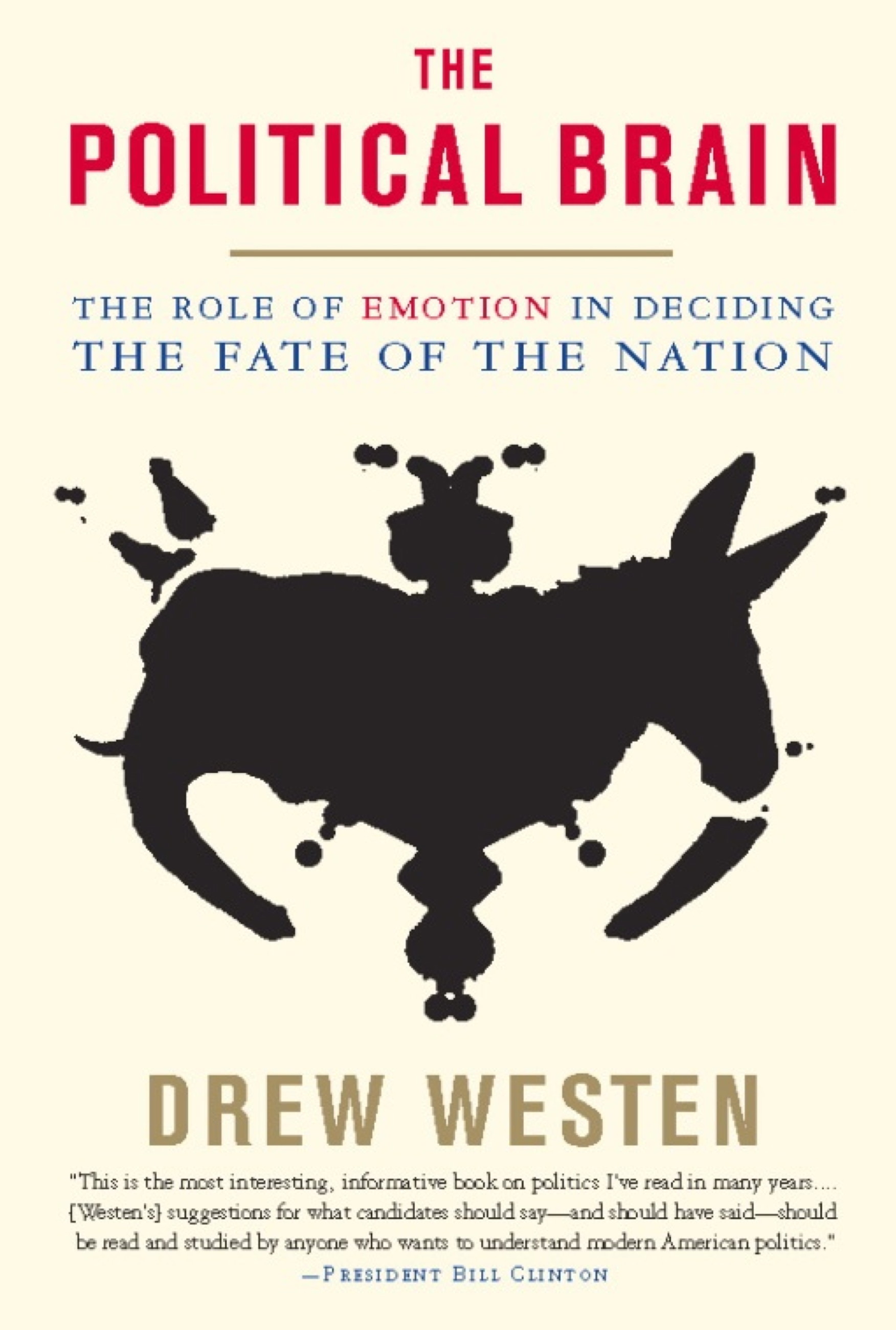
The Political Brain The Political Brain is a groundbreaking investigation into the role of emotion in determining the political life of the nation. For two decades Drew Westen, professor of psychology and psychiatry at Emory University, has explored a theory of the mind that differs substantially from the more "dispassionate" notions held by most cognitive psychologists, political scientists, and economists -- and Democratic campaign strategists. The idea of the mind as a cool calculator that makes decisions by weighing the evidence bears no relation to how the brain actually works. When political candidates assume voters dispassionately make decisions based on "the issues," they lose. That's why only one Democrat has been re-elected to the presidency since Franklin Roosevelt -- and only one Republican has failed in that quest. In politics, when reason and emotion collide, emotion invariably wins. Elections are decided in the marketplace of emotions, a marketplace filled with values, images, analogies, moral sentiments, and moving oratory, in which logic plays only a supporting role. Westen shows, through a whistle-stop journey through the evolution of the passionate brain and a bravura tour through fifty years of American presidential and national elections, why campaigns succeed and fail. The evidence is overwhelming that three things determine how people vote, in this order: their feelings toward the parties and their principles, their feelings toward the candidates, and, if they haven't decided by then, their feelings toward the candidates' policy positions. Westen turns conventional political analyses on their head, suggesting that the question for Democratic politics isn't so much about moving to the right or the left but about moving the electorate. He shows how it can be done through examples of what candidates have said -- or could have said -- in debates, speeches, and ads. Westen's discoveries could utterly transform electoral arithmetic, showing how a different view of the mind and brain leads to a different way of talking with voters about issues that have tied the tongues of Democrats for much of forty years -- such as abortion, guns, taxes, and race. You can't change the structure of the brain. But you can change the way you appeal to it. And here's how POLITICAL SCIENCE,Political Process,Campaigns & Elections
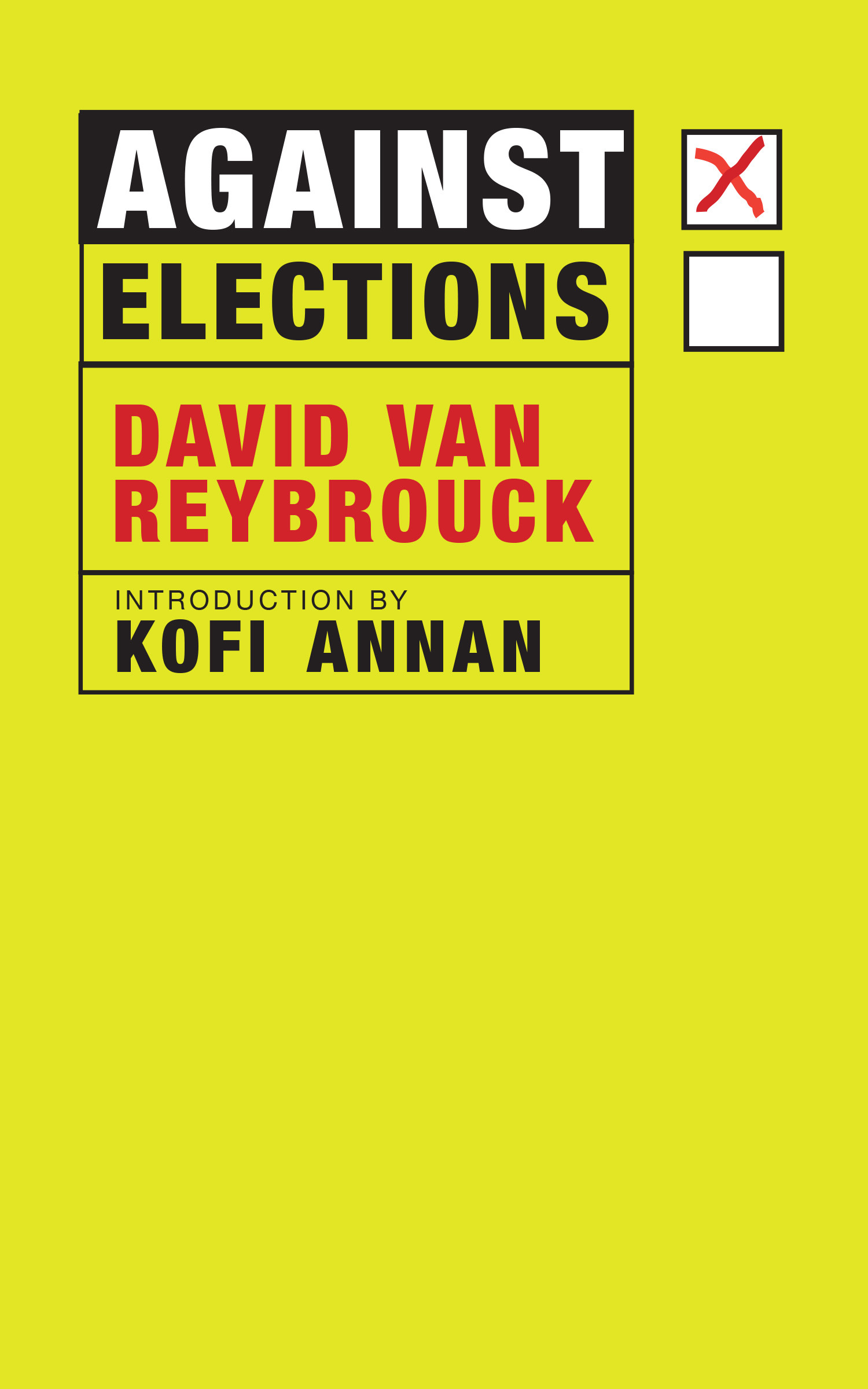
Against Elections A small book with great weight and urgency to it, this is both a history of democracy and a clarion call for change. "Without drastic adjustment, this system cannot last much longer," writes Van Reybrouck, regarded today as one of Europe's most astute thinkers. "If you look at the decline in voter turnout and party membership, and at the way politicians are held in contempt, if you look at how difficult it is to form governments, how little they can do and how harshly they are punished for it, if you look at how quickly populism, technocracy and anti-parliamentarianism are rising, if you look at how more and more citizens are longing for participation and how quickly that desire can tip over into frustration, then you realize we are up to our necks." Not so very long ago, the great battles of democracy were fought for the right to vote. Now, Van Reybrouck writes, "it's all about the right to speak, but in essence it's the same battle, the battle for political emancipation and for democratic participation. We must decolonize democracy. We must democratize democracy." As history, Van Reybrouck makes the compelling argument that modern democracy was designed as much to preserve the rights of the powerful and keep the masses in line, as to give the populace a voice. As change-agent, Against Elections makes the argument that there are forms of government, what he terms sortitive or deliberative democracy, that are beginning to be practiced around the world, and can be the remedy we seek. In Iceland, for example, deliberative democracy was used to write the new constitution. A group of people were chosen by lot, educated in the subject at hand, and then were able to decide what was best, arguably, far better than politicians would have. A fascinating, and workable idea has led to a timely book to remind us that our system of government is a flexible instrument, one that the people have the power to change. POLITICAL SCIENCE,Political Process,Campaigns & Elections

Hacks NEW YORK TIMES BESTSELLER "Explosive... A blistering tell-all."--- Washington Post "People should sit up, take notes and change things."---Ace Smith, Los Angeles Times "Brazile most certainly has a story to tell.... Vivid."--- The Guardian From Donna Brazile, former DNC chair and legendary political operative, an explosive and revealing new look at the 2016 election: the first insider account of the Russian hacking of the DNC and the missteps by the Clinton campaign and Obama administration that enabled a Trump victory. In the fallout of the Russian hacking of the Democratic National Committee--and as chaos threatened to consume the party's convention--Democrats turned to a familiar figure to right the ship: Donna Brazile. Known to millions from her frequent TV appearances, she was no stranger to high stakes and dirty opponents, and the longtime Democratic strategist had a reputation in Washington as a one-stop shop for fixing sticky problems. What Brazile found at the DNC was unlike anything she had experienced before--and much worse than is commonly known. The party was beset by infighting, scandal, and hubris, while reeling from a brazen and wholly unprecedented attempt by a foreign power to influence the presidential election. Plus, its candidate, Hillary Clinton, faced an opponent who broke every rule in the political playbook. Packed with never-before-reported revelations about what went down in 2016, Hacks is equal parts campaign thriller, memoir, and roadmap for the future. With Democrats now in the wilderness after this historic defeat, Hacks argues that staying silent about what went wrong helps no one. Only by laying bare the missteps, miscalculations, and crimes of 2016, Brazile contends, will Americans be able to salvage their democracy. POLITICAL SCIENCE,Political Process,Campaigns & Elections
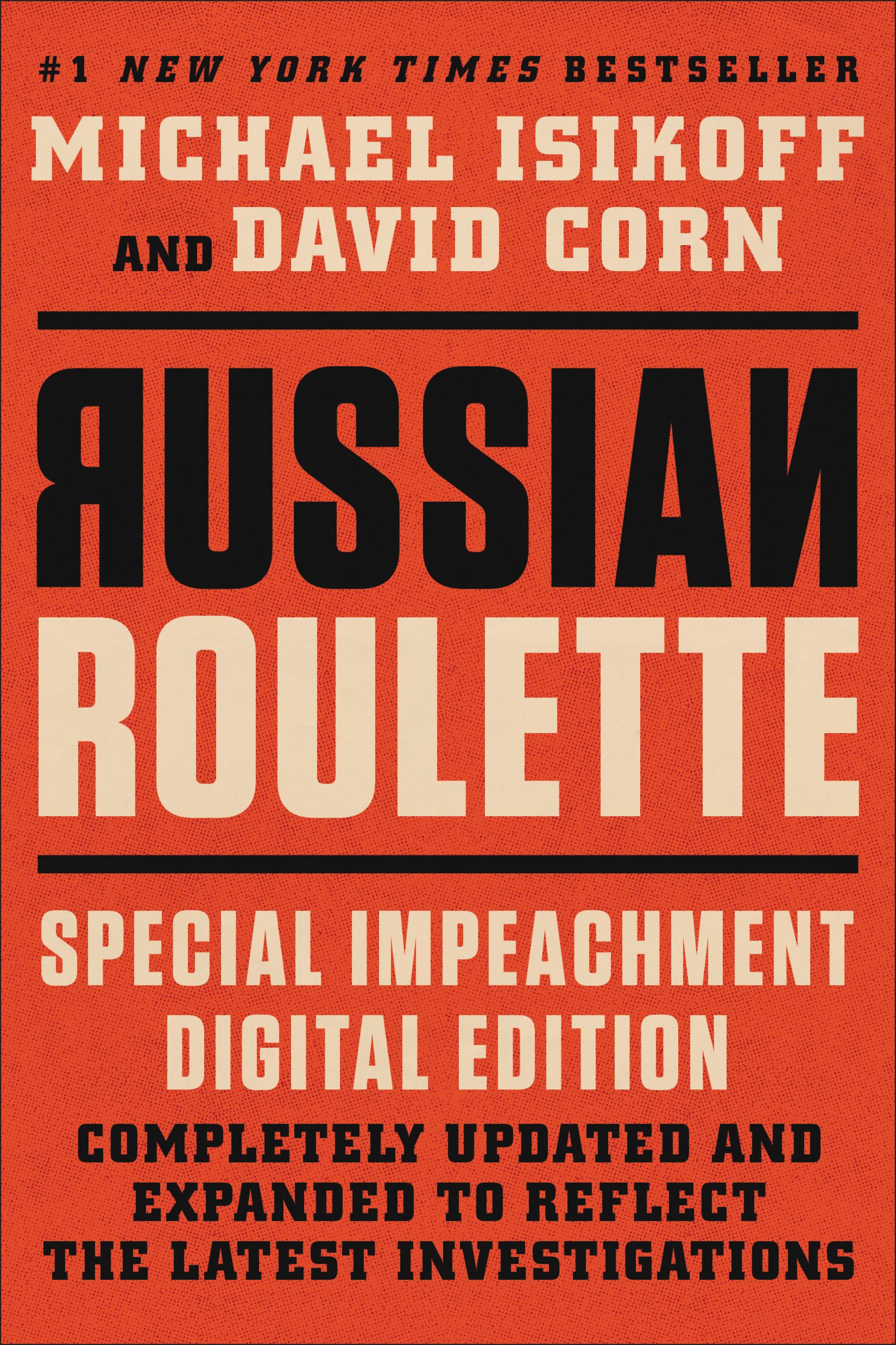
Russian Roulette The incredible, harrowing account of how American democracy was hacked by Moscow as part of a covert operation to influence the U.S. election and help Donald Trump gain the presidency. "Russian Roulette is...the most thorough and riveting account." -- The New York Times Russian Roulette is a story of political skullduggery unprecedented in American history. It weaves together tales of international intrigue, cyber espionage, and superpower rivalry. After U.S.-Russia relations soured, as Vladimir Putin moved to reassert Russian strength on the global stage, Moscow trained its best hackers and trolls on U.S. political targets and exploited WikiLeaks to disseminate information that could affect the 2016 election. The Russians were wildly successful and the great break-in of 2016 was no "third-rate burglary." It was far more sophisticated and sinister -- a brazen act of political espionage designed to interfere with American democracy. At the end of the day, Trump, the candidate who pursued business deals in Russia, won. And millions of Americans were left wondering, what the hell happened? This story of high-tech spying and multiple political feuds is told against the backdrop of Trump's strange relationship with Putin and the curious ties between members of his inner circle -- including Paul Manafort and Michael Flynn -- and Russia. Russian Roulette chronicles and explores this bizarre scandal, explains the stakes, and answers one of the biggest questions in American politics: How and why did a foreign government infiltrate the country's political process and gain influence in Washington? POLITICAL SCIENCE,Political Process,Campaigns & Elections
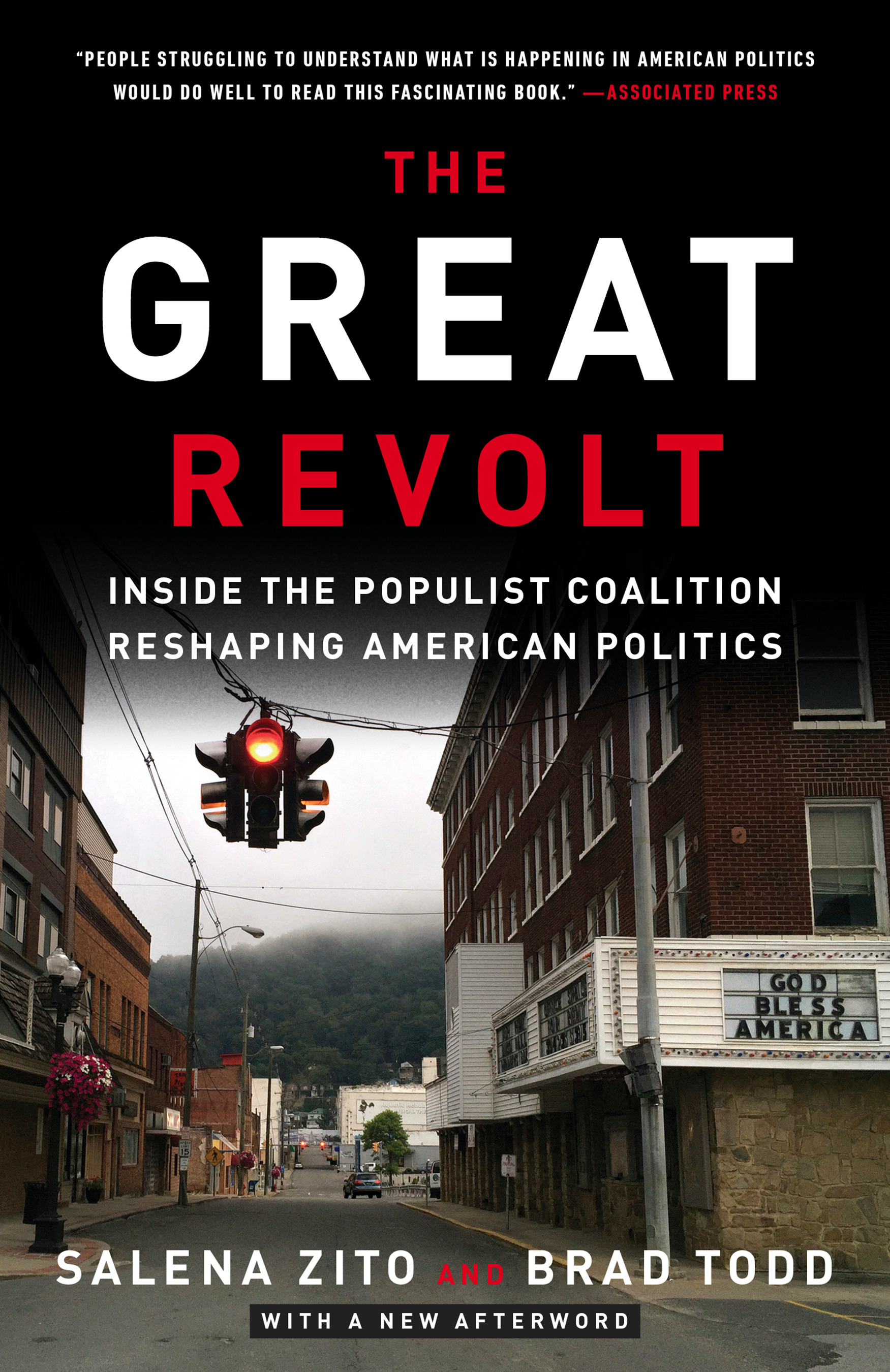
The Great Revolt A CNN political analyst and a Republican strategist reframe the discussion of the “Trump voter” to answer the question, What’s next? NAMED ONE OF THE BEST BOOKS OF THE YEAR BY FOREIGN AFFAIRS • “Unlike most retellings of the 2016 election, The Great Revolt provides a cohesive, non-wild-eyed argument about where the Republican Party could be headed.”—The Atlantic Political experts were wrong about the 2016 election and they continue to blow it, predicting the coming demise of the president without pausing to consider the durability of the winds that swept him into office. Salena Zito and Brad Todd have traveled over 27,000 miles of country roads to interview more than three hundred Trump voters in ten swing counties. What emerges is a portrait of a group of citizens who span job descriptions, income brackets, education levels, and party allegiances, united by their desire to be part of a movement larger than themselves. They want to put pragmatism before ideology and localism before globalism, and demand the respect they deserve from Washington. The 2016 election signaled a realignment in American politics that will outlast any one president. Zito and Todd reframe the discussion of the “Trump voter” to answer the question, What’s next? POLITICAL SCIENCE,Political Process,Campaigns & Elections
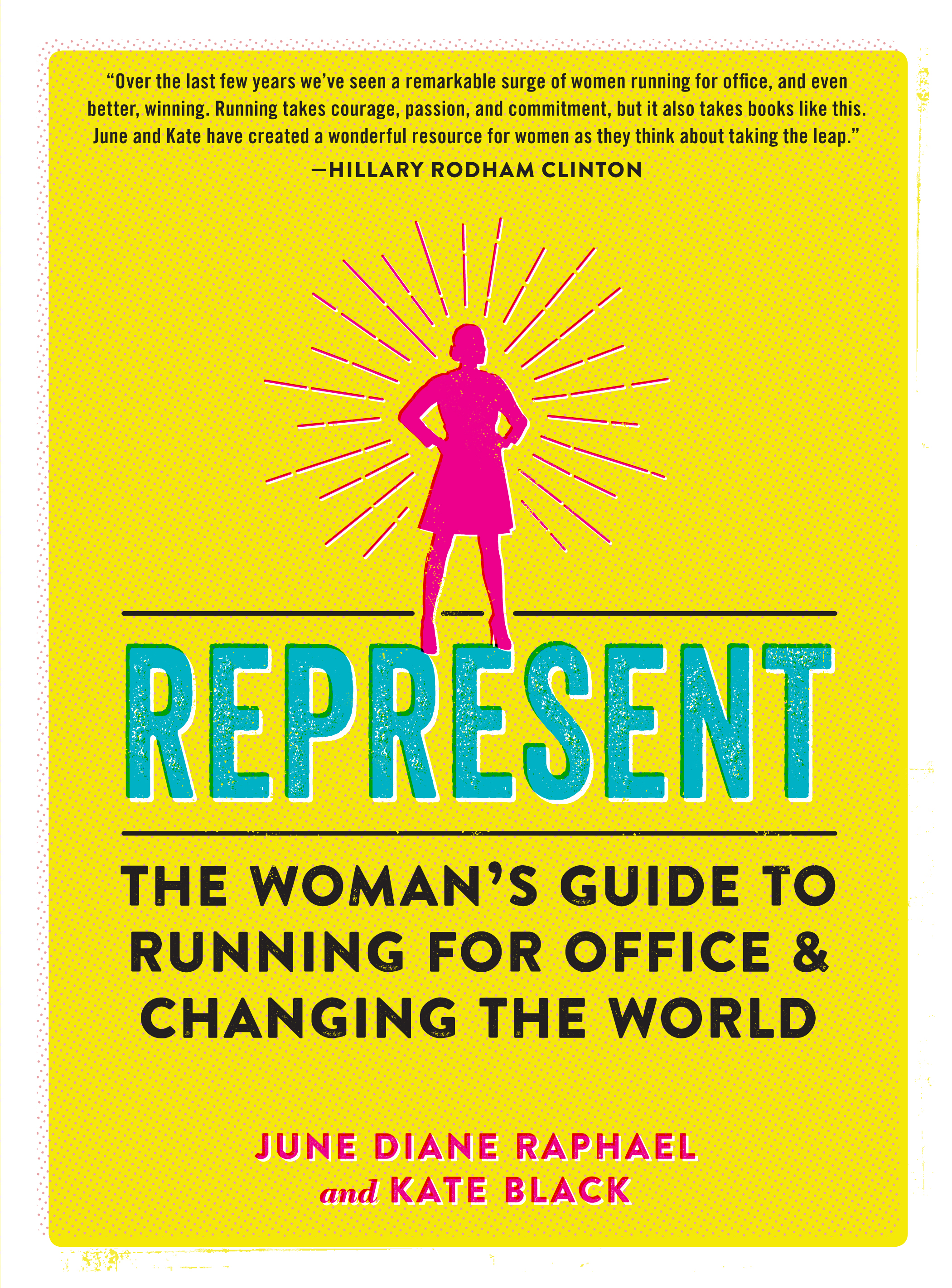
Represent A comprehensive, lively, interactive woman's guide to running for office that comes with a sense of humor and of style. Practical, how-to text is combined with elements of a workbook/planner to inspire potential female candidates, whether they're running for office on the local, state, or national level (from school board to senator). POLITICAL SCIENCE,Political Process,Campaigns & Elections

Proof of Collusion For the first time, the full, explosive record of the unthinkable: how a US president compromised American foreign policy in exchange for the promise of future business and covert election assistance. Looking back at this moment in history, historians will ask if Americans knew they were living through the first case of criminal conspiracy between an American presidential candidate turned commander in chief and a geopolitical enemy. The answer might be: it was hard to see the whole picture. The stories coming in from around the globe have often seemed fantastical: clandestine meetings in foreign capitals, secret recordings in a Moscow hotel, Kremlin agents infiltrating the Trump inner circle... Seth Abramson has tracked every one of these far-flung reports and now in, Proof of Collusion, he finally gives us a record of the unthinkable—a president compromising American foreign policy in exchange for the promise of future business and covert election assistance. The attorney, professor, and former criminal investigator has used his exacting legal mind and forensic acumen to compile, organize, and analyze every piece of the Trump-Russia story. His conclusion is clear: the case for collusion is staring us in the face. Drawing from American and European news outlets, he takes readers through the Trump-Russia scandal chronologically, putting the developments in context and showing how they connect. His extraordinary march through all the public evidence includes: —How Trump worked for thirty years to expand his real estate empire into Russia even as he was rescued from bankruptcy by Putin’s oligarchs and Kremlin agents. —How Russian intelligence gathered compromising material on him over multiple trips. —How Trump recruited Russian allies and business partners while running for president. —How he surrounded himself with advisers who engaged in clandestine negotiations with Russia. —How Trump aides and family members held secret meetings with foreign agents and lied about them. By pulling every last thread of this complicated story together, Abramson argues that—even in the absence of a Congressional investigation or a report from Special Counsel Mueller—the public record already indicates a quid pro quo between Trump and the Kremlin. The most extraordinary part of the case for collusion is that so much of it unfolded in plain sight. POLITICAL SCIENCE,Political Process,Campaigns & Elections

France After 2012 In May 2012, French voters rejected the liberalizing policies of Nicolas Sarkozy and elected his opponent, the Socialist François Hollande, president. In June 2012, the incumbent president’s center-right UMP party was swept out of government in the ensuing parliamentary elections, giving way to a new center-left majority in the National Assembly. This book analyzes the contexts and results of the 2012 presidential and parliamentary elections in France. It assesses the legacies of the Sarkozy presidency that informed the 2012 electoral campaigns, scrutinizing his domestic social and economic policies on the one hand and European and foreign policies on the other. In turn, the elections’ outcomes are also analyzed from the standpoint of various political parties and other institutional interests in France, and the results are situated within the broader run of French political history. Finally, the book examines the principal challenges facing the Hollande administration and new government of Prime Minister Jean-Marc Ayrault, and assesses how effectively these have been met during their first year in office. POLITICAL SCIENCE,Political Process,Campaigns & Elections
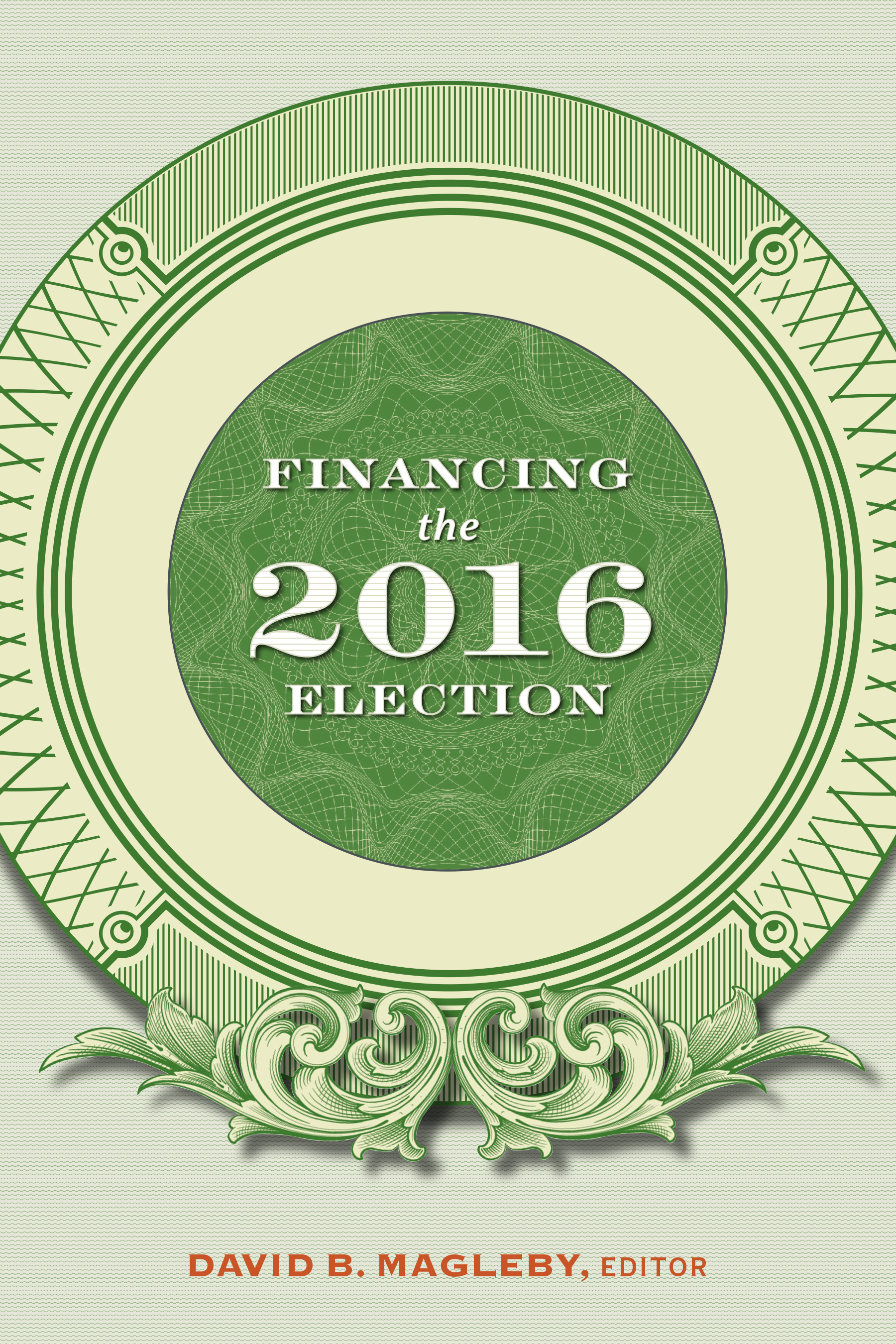
Financing the 2016 Election Money and politics in an election that broke the mold Beginning with the 1960 election, readers could turn to one book for an authoritative and comprehensive examination of campaign finance at the federal level. Now, the latest in this respected series, Financing the 2016 Election, explores the role of money in one of the most unconventional elections in modern American history. A team of leading scholars has dug into the roles played by political parties and special interest groups (including their Super PACS) in the presidential and congressional elections of 2016. David Magleby and his team of experts examined Federal Elections Commission reports and interviewed dozens of key participants, including representatives of virtually all the major interest groups active in the 2016 election cycle. They place that election in the context of how U.S. elections have been financed during recent decadesa context that illustrates how dramatically different campaign finance is today from the past. Among the most important changes has been the growth of so-called Super PACS, which have become increasingly important both in the financing they provide candidates and in their ability to act independently, both for and against candidates. Overall, Super PACS doubled their spending in 2016 from four years earlier. Taking a comprehensive approach, this book helps readers understand how the financing of electionsincluding the increasing reliance by candidates on outside special interest groupsultimately affects politics and public policy. POLITICAL SCIENCE,Political Process,Campaigns & Elections

Get Out the Vote The first edition of Get Out the Vote! broke ground by introducing a new scientific approach to the challenge of voter mobilization and profoundly influenced how campaigns operate. In this expanded and updated edition, the authors incorporate data from more than one hundred new studies, which shed new light on the cost-effectiveness and efficiency of various campaign tactics, including door-to-door canvassing, e-mail, direct mail, and telephone calls. Two new chapters focus on the effectiveness of mass media campaigns and events such as candidate forums and Election Day festivals. Available in time for the core of the 2008 presidential campaign, this practical guide on voter mobilization is sure to be an important resource for consultants, candidates, and grassroots organizations. Praise for the first edition: "Donald P. Green and Alan S. Gerber have studied turnout for years. Their findings, based on dozens of controlled experiments done as part of actual campaigns, are summarized in a slim and readable new book called Get Out the Vote!, which is bound to become a bible for politicians and activists of all stripes." Alan B. Kreuger, in the New York Times "Get Out the Vote! shatters conventional wisdom about GOTV." Hal Malchow in Campaigns & Elections "Green and Gerber's recent book represents important innovations in the study of turnout."Political Science Review "Green and Gerber have provided a valuable resource for grassroots campaigns across the spectrum."National Journal POLITICAL SCIENCE,Political Process,Campaigns & Elections
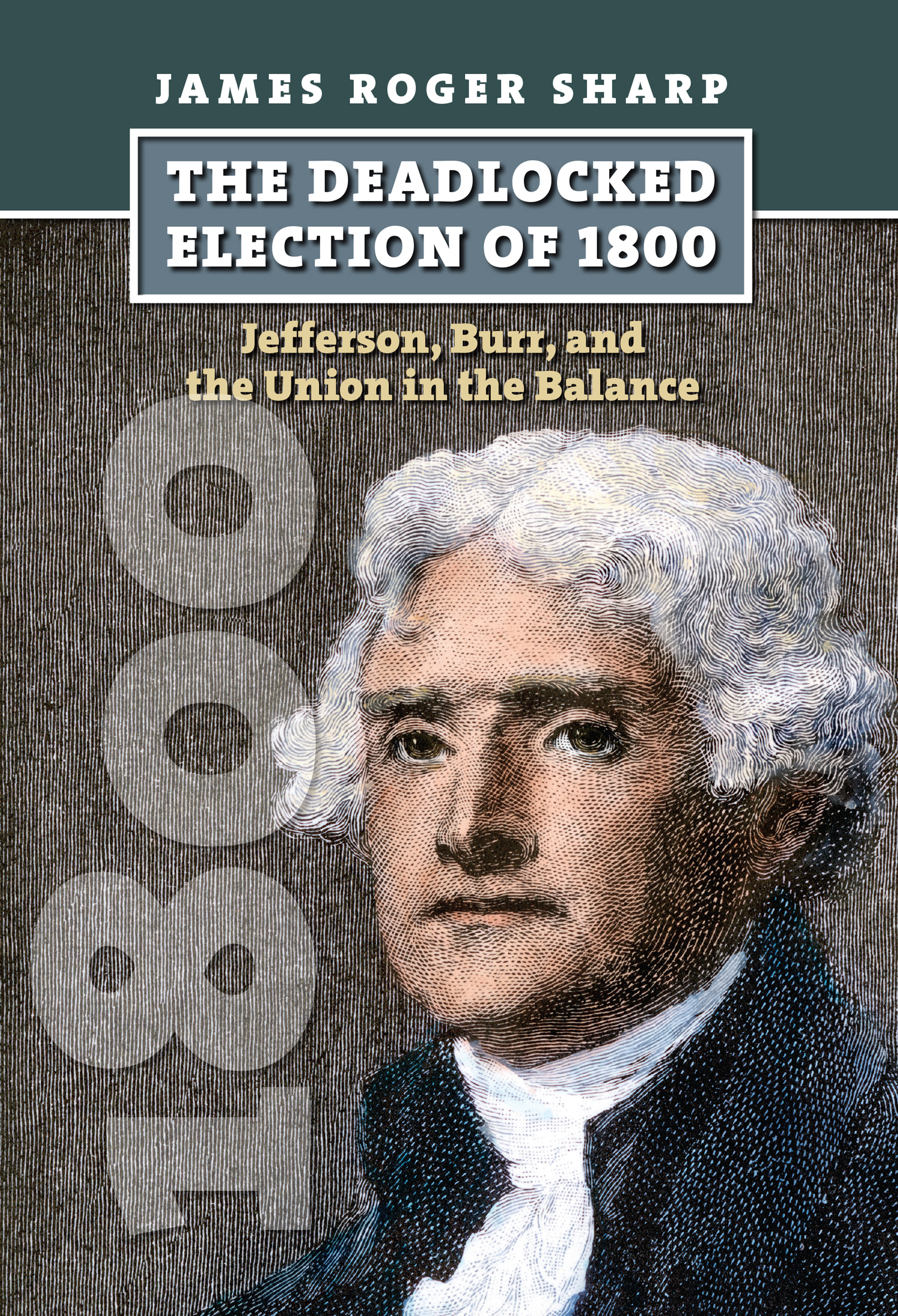
The Deadlocked Election of 1800 "Sharp’s study succeeds brilliantly in reconstructing the great crisis of the union that the deadlocked election of 1800 precipitated."— Review of Politics "Distinguished historian Sharp has provided both students and generalists of the early American republic with a compelling, concisely written political analysis of one of the most pivotal elections in the nation’s history. With a well-written narrative and an intriguing cast of larger-than-life characters, including Jefferson, Burr, Adams, Hamilton, and a host of others, Sharp’s lucid work brings the electoral politics of the early republic into clear academic focus. Highly recommended."— Choice "Sharp’s study succeeds brilliantly in reconstructing the great crisis of the union that the deadlocked election of 1800 precipitated."— Review of Politics POLITICAL SCIENCE,Political Process,Campaigns & Elections
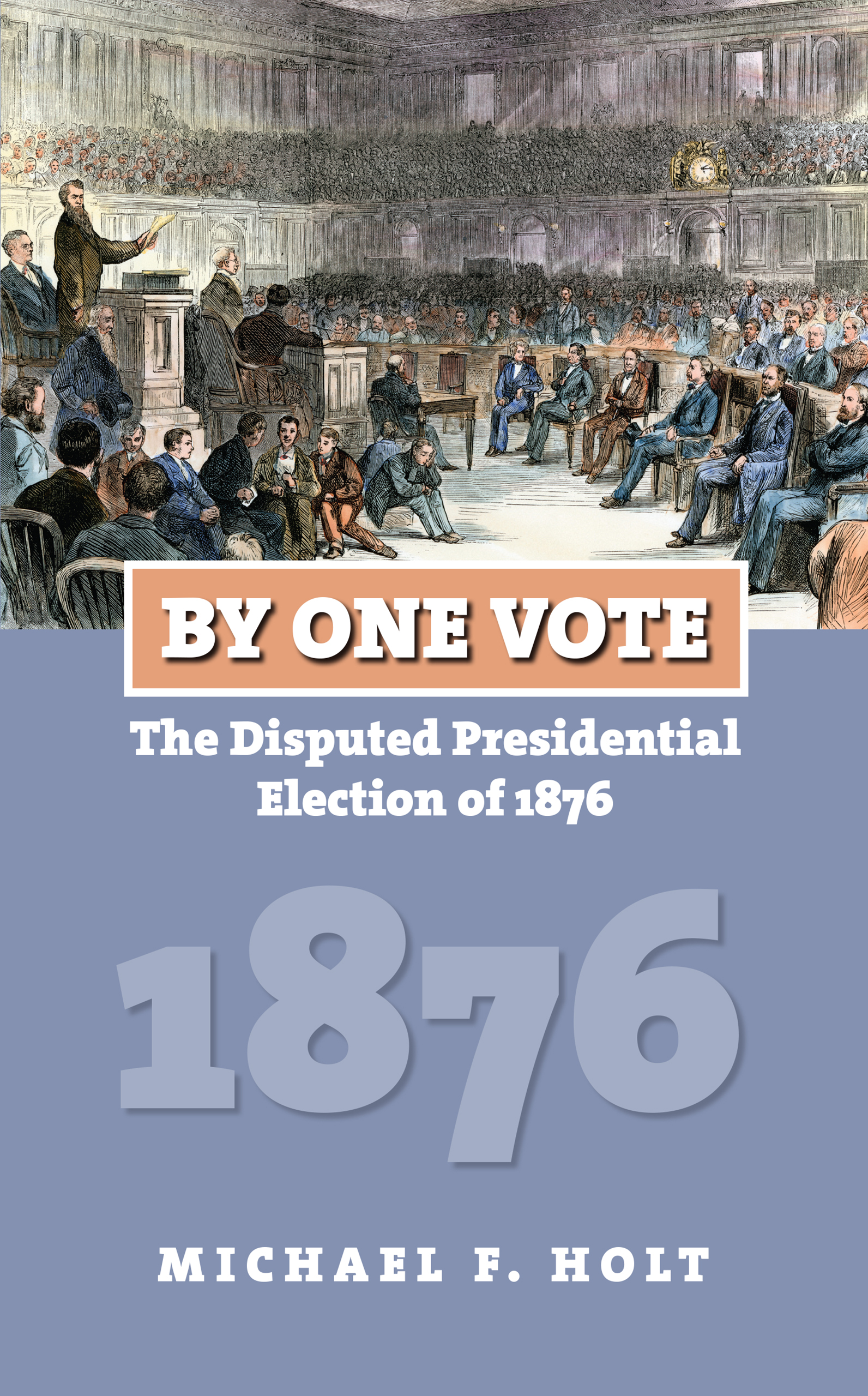
By One Vote "The most comprehensive account to date of the presidential election that effectively ended Reconstruction and in some ways foreshadowed another disputed contest a century and a quarter later."— Journal of American History "A richly textured account interwoven with manifold insights regarding political motive and maneuver. Holt’s fellow antebellum historians will recognize the hand of the master at work here, while specialists in late nineteenth-century politics will welcome his provocative, sometimes controversial, analyses."— Reviews in American History "All students of U.S. political history will want to read this book. Recommended. All levels/libraries."— Choice "Holt uses great writing amid terse exposition of exceedingly complex procedural issues to tease out explanation and meaning. . . . An outstanding contribution."— H-Net Reviews POLITICAL SCIENCE,Political Process,Campaigns & Elections
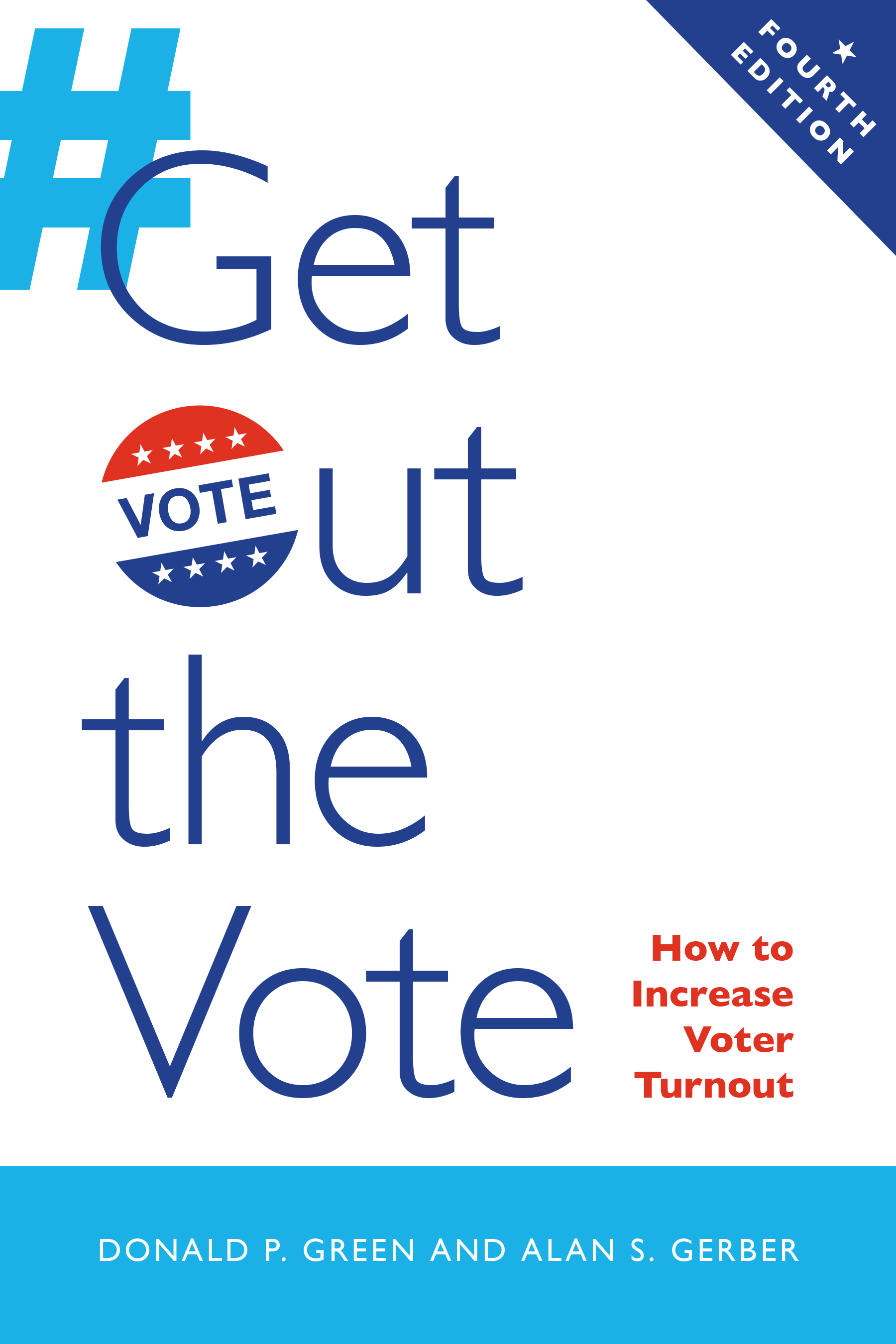
Get Out the Vote The most important element in every election is getting voters to the pollsthese get-out-the-vote (GOTV) efforts make the difference between winning and losing office. With the first three editions of Get Out the Vote, Donald P. Green and Alan S. Gerber broke ground by introducing a new scientific approach to the challenge of voter mobilization and profoundly transformed how campaigns operate. Get Out the Vote has become the reference text for those who manage campaigns and study voter mobilization. In this expanded and updated edition, Green and Gerber incorporate data from a trove of recent studies that shed new light on the cost-effectiveness and efficiency of various campaign tactics, including door-to-door canvassing, e-mail, direct mail, and telephone calls. The new edition gives special attention to “relational organizing†through friend-to-friend communication and events. Available in time for the 2020 presidential campaign, this practical guide to voter mobilization will again be a must-read for consultants, candidates, and grassroots organizations. POLITICAL SCIENCE,Political Process,Campaigns & Elections

The Hill to Die On NEW YORK TIMES BESTSELLER • The inside story of Donald Trump’s first two years in Washington as viewed from Capitol Hill, a startling account that turns “Congress into a Game of Thrones book” (Trevor Noah, The Daily Show). Taking readers into secret strategy calls and closed-door meetings from the House to the White House, Politico Playbook writers Jake Sherman and Anna Palmer trace the gamesmanship and the impulsiveness, the dealmaking and the backstabbing, in a blow-by-blow account of the power struggle that roiled Congress. Moving from the fights for advantage between Donald Trump, Nancy Pelosi, and Chuck Schumer; to Mitch McConnell’s merciless, Machiavellian handling of the sexual assault accusations against Supreme Court nominee Brett Kavanaugh; to Paul Ryan’s desperate, failed attempts to keep Mark Meadows from pushing Trump into a government shutdown over immigration, The Hill to Die On bristles with fresh news and tells the story of what really happened in some of the most defining moments our era. Like The West Wing for Congress, or Shattered meets This Town, The Hill to Die On tells an unforgettable story of politics and power, where the stakes going forward are nothing less than the future of America and the lives of millions of ordinary Americans. Praise for The Hill to Die On “[Sherman and Palmer] go deep inside the halls of Congress to document the deal making, backstabbing, power struggles and political knife fights that have roiled the nation’s capital during President Donald Trump’s first two years in office. . . . Anything but boring.”—USA Today, “5 Books Not to Miss” “[The Hill to Die On] painstakingly chronicles the return to divided government and the restoration of an institutional check on a mercurial chief executive. . . . The book depicts a foul-mouthed president in love with his own reflection, a House GOP encased in the amber of self-delusion, and Nancy Pelosi’s unblinking focus on twin prizes: recapturing the House and returning to the speaker’s chair.”—The Guardian “If you are one of the many Americans who hates Congress, this book is for you. In the Washington depicted in Jake Sherman and Anna Palmer’s new book, there are no heroes—only winners and losers. . . . With these lawmakers, Sherman and Palmer get inside their heads and capture what they’re thinking in real time.”—The Washington Post POLITICAL SCIENCE,Political Process,Campaigns & Elections
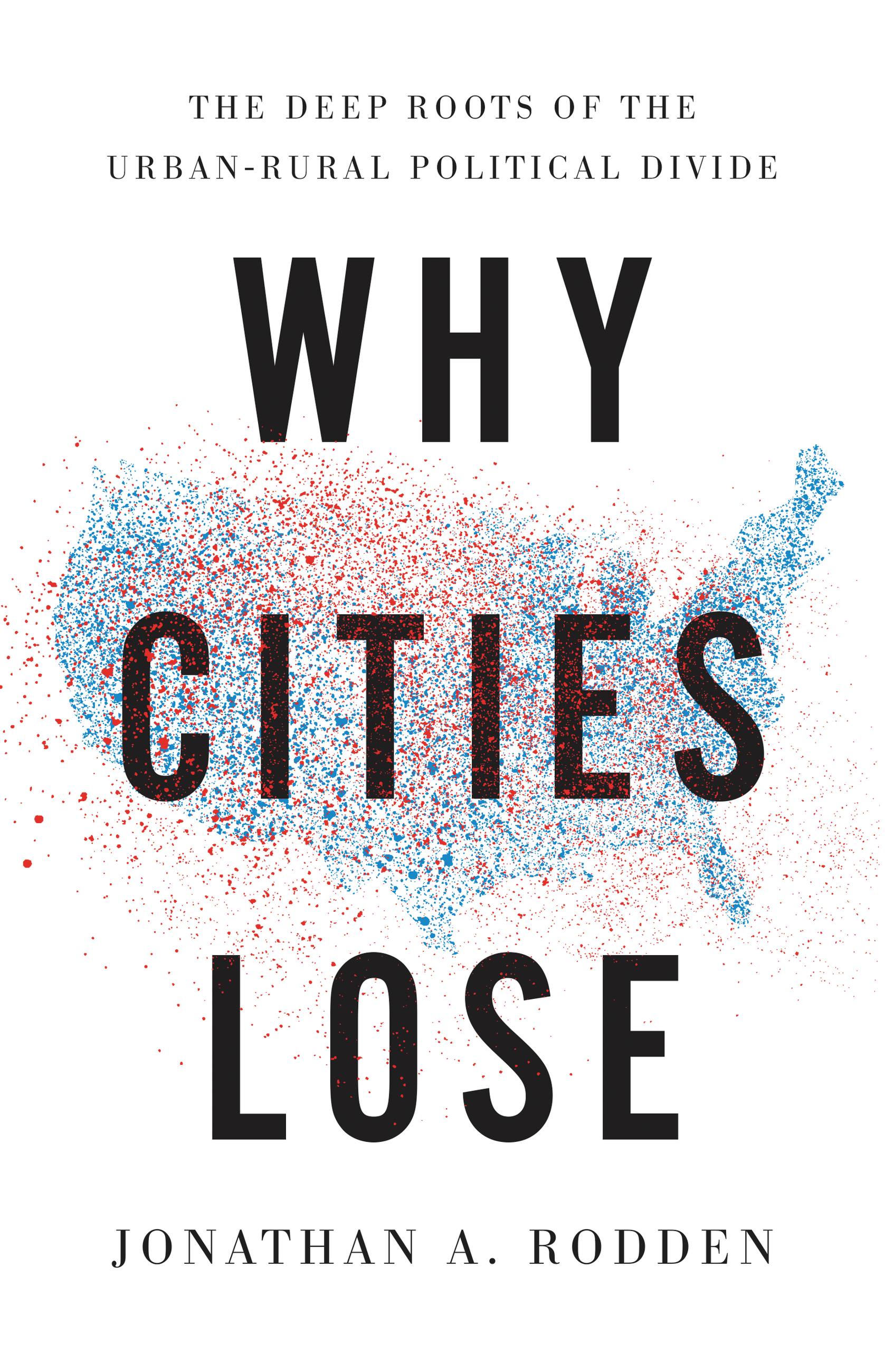
Why Cities Lose A prizewinning political scientist traces the origins of urban-rural political conflict and shows how geography shapes elections in America and beyond Why is it so much easier for the Democratic Party to win the national popular vote than to build and maintain a majority in Congress? Why can Democrats sweep statewide offices in places like Pennsylvania and Michigan yet fail to take control of the same states' legislatures? Many place exclusive blame on partisan gerrymandering and voter suppression. But as political scientist Jonathan A. Rodden demonstrates in Why Cities Lose, the left's electoral challenges have deeper roots in economic and political geography. In the late nineteenth century, support for the left began to cluster in cities among the industrial working class. Today, left-wing parties have become coalitions of diverse urban interest groups, from racial minorities to the creative class. These parties win big in urban districts but struggle to capture the suburban and rural seats necessary for legislative majorities. A bold new interpretation of today's urban-rural political conflict, Why Cities Lose also points to electoral reforms that could address the left's under-representation while reducing urban-rural polarization. POLITICAL SCIENCE,Political Process,Campaigns & Elections
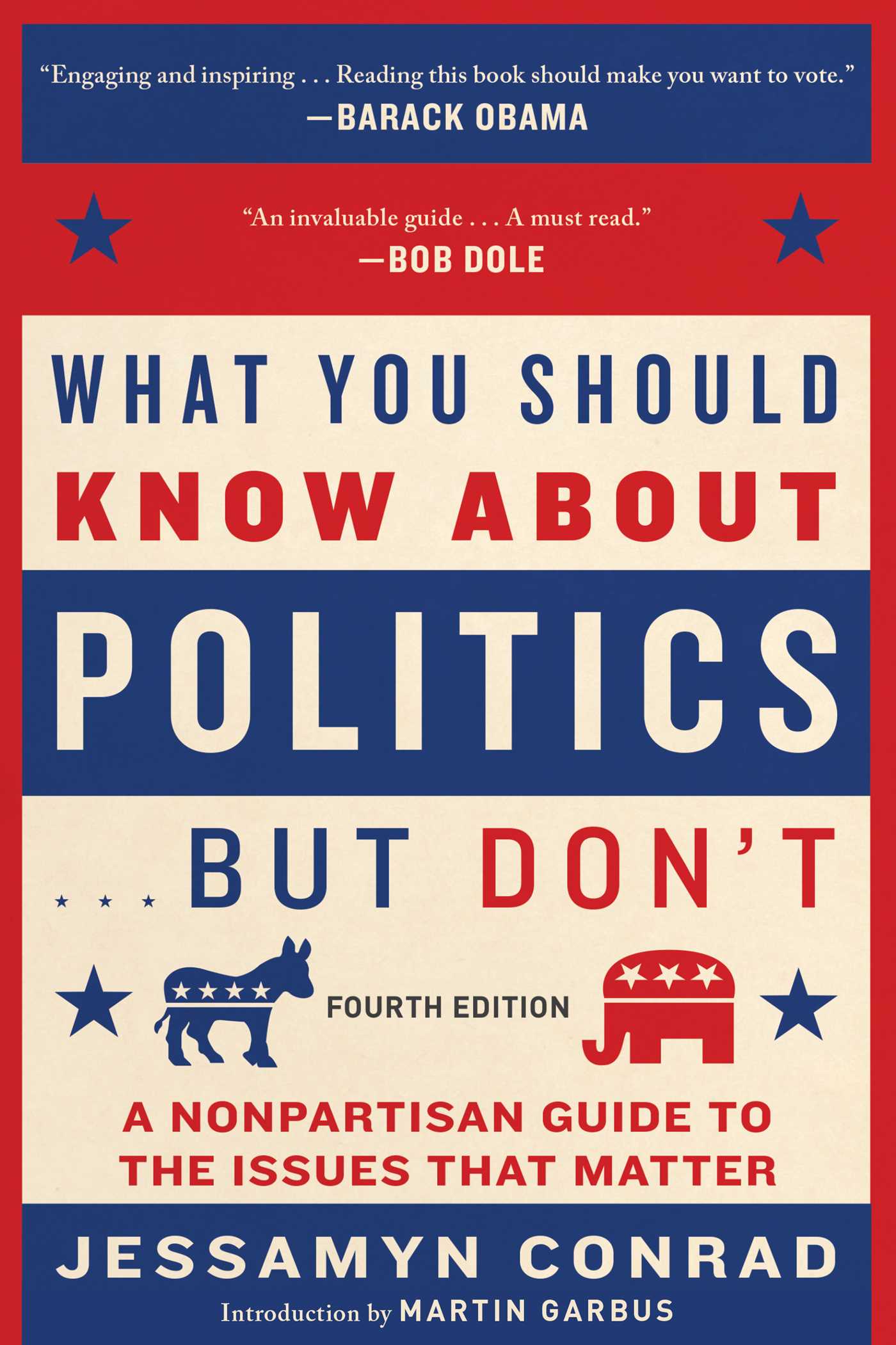
What You Should Know About Politics . . . But Don't, Fourth Edition “Engaging and inspiring . . . Reading this book should make you want to vote.â€â€”Barack Obama In a world of sound bites, deliberate misinformation, and a political scene colored by the blue versus red partisan divide, how does the average educated American find a reliable source that’s free of political spin? What You Should Know About Politics . . . But Don’t breaks it all down, issue by issue, explaining who stands for what, and why—whether it’s the economy, income inequality, Obamacare, foreign policy, education, immigration, or climate change. If you’re a Democrat, a Republican, or somewhere in between, it’s the perfect book to brush up on a single topic or read through to get a deeper understanding of the often murky world of American politics. This is an essential volume for understanding the background to the 2020 presidential election. But it is also a book that transcends the season. It’s truly for anyone who wants to know more about the perennial issues that will continue to affect our everyday lives. The fourth edition includes an introduction by Martin Garbus discussing the themes and issues that have come to the fore during the present presidential cycle. POLITICAL SCIENCE,Political Process,Campaigns & Elections
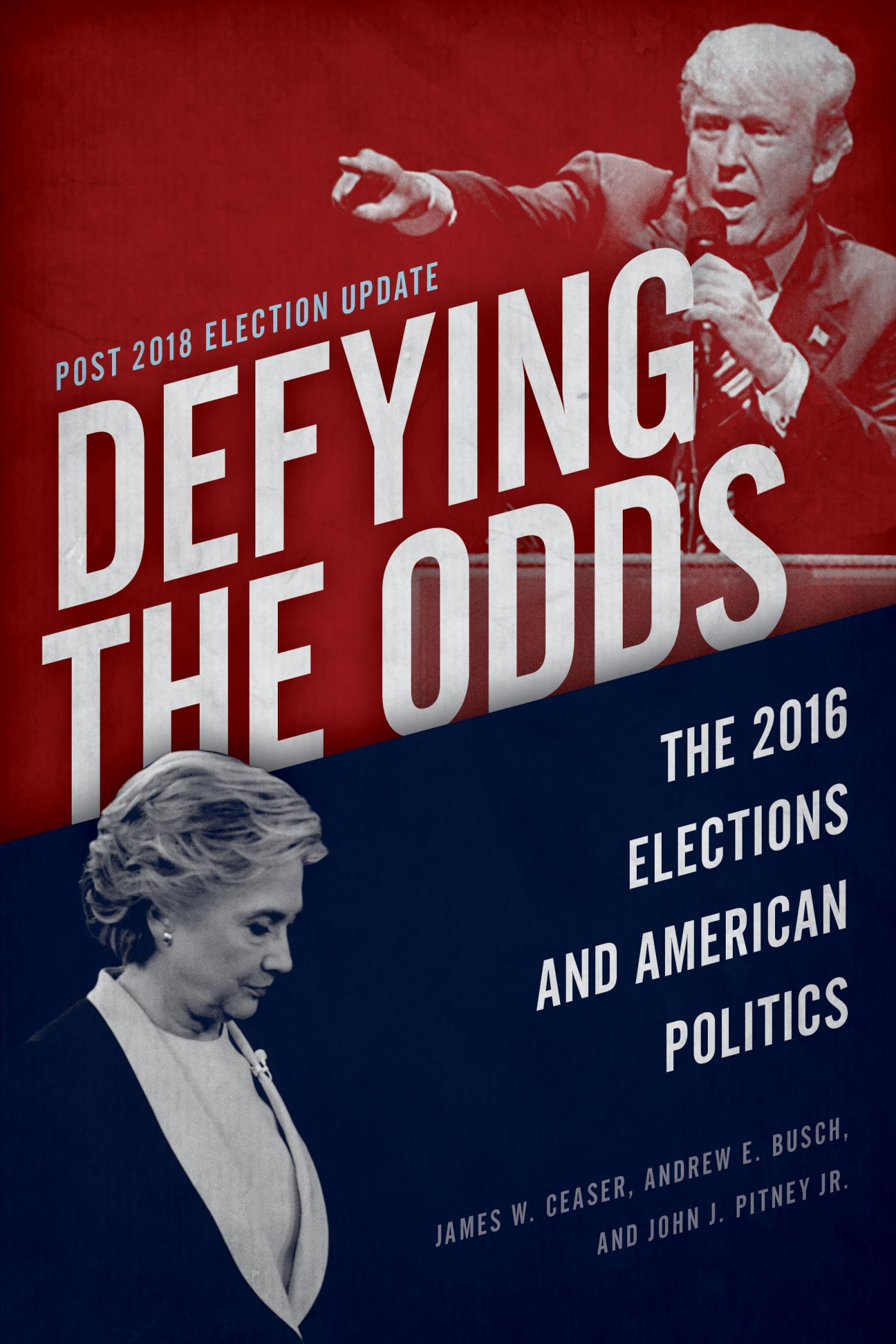
Defying the Odds As they have every four years since 1992, James W. Ceaser and Andrew E. Busch—now joined by John J. Pitney, Jr.—once again provide the most comprehensive and authoritative account of the presidential election. POLITICAL SCIENCE,Political Process,Campaigns & Elections

They Said This Day Would Never Come The thrilling, unlikely story of Barack Obama's first presidential campaign, as told by the volunteers and staff who propelled the longshot candidate to the presidency In the year leading up to the Iowa caucuses, few thought a freshman senator named Barack Hussein Obama would be able to win the Democratic nomination--not to mention become the most popular leader in the world. But something was stirring. Hundreds of young people from all over the country began assembling first in Iowa. These "kids" became the foundation of one of the most improbable presidential campaigns of the modern era. Chris Liddell-Westefeld was one of those kids. He and thousands of other staff and volunteers dedicated every minute of their time, intelligence, and resources to help elect Barack Obama, as what started in the midwest spread nationwide. Drawn from more than 200 interviews with alumni including David Axelrod, David Plouffe, Alyssa Mastromonaco, Dan Pfeiffer, Valerie Jarrett, Josh Earnest, Tommy Vietor, Jon Favreau, and President Obama himself, They Said This Day Would Never Come takes readers deep inside the most inspirational presidential campaign in recent history. POLITICAL SCIENCE,Political Process,Campaigns & Elections
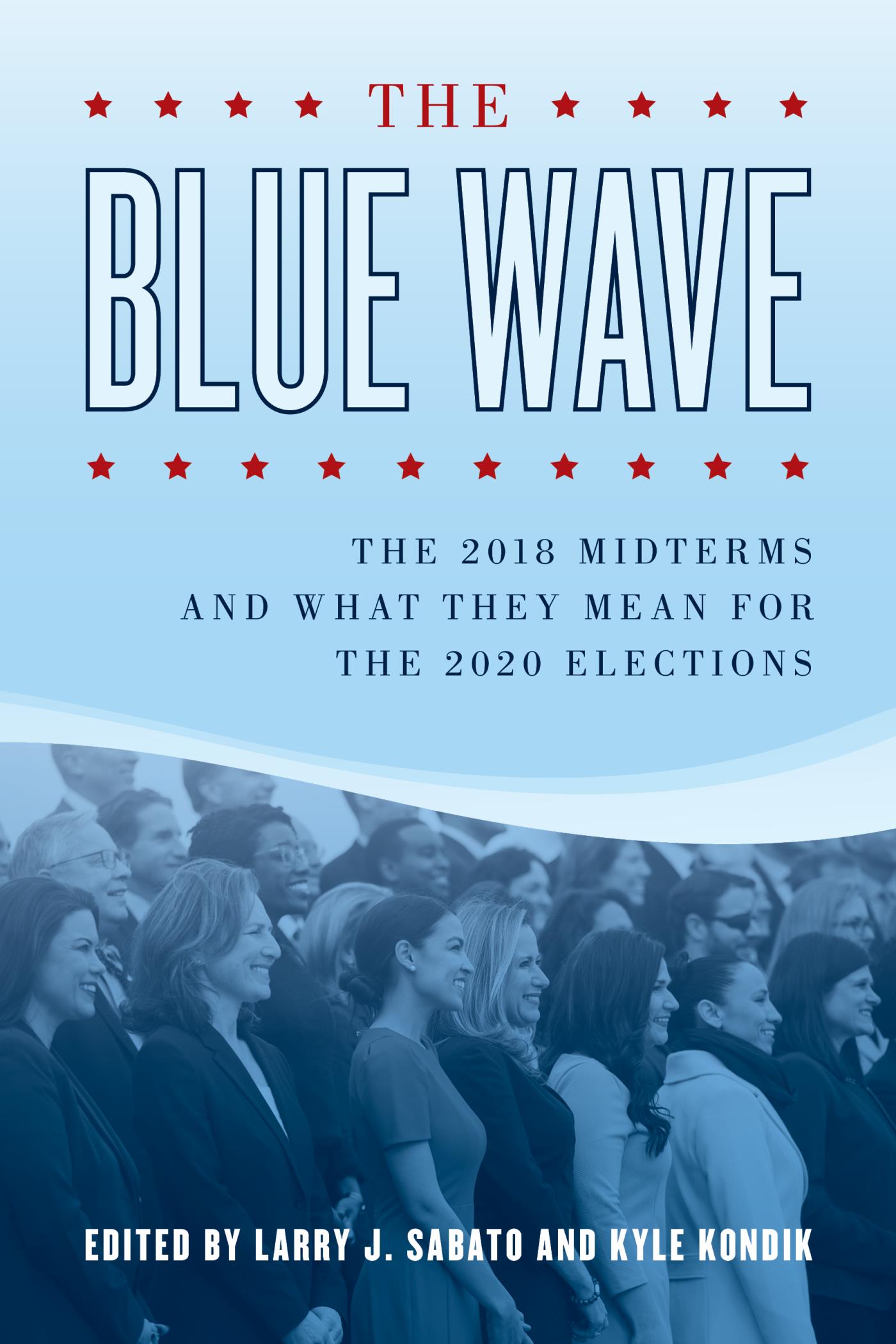
The Blue Wave In this timely book, Larry Sabato and Kyle Kondik bring together respected journalists and academics from across the political spectrum to examine every facet of the 2018 election, and what its outcome portends for our national politics and the coming 2020 presidential election. POLITICAL SCIENCE,Political Process,Campaigns & Elections

Running Against the Devil NEW YORK TIMES BESTSELLER • A savvy guidebook for beating Trump’s tricks, traps, and tweets from a founder of The Lincoln Project, now updated with new material on the historic battle between Trump and Joe Biden—and how Covid-19 has changed the race “If you believe America’s future depends on Donald Trump’s political machine being crushed at the polls next year, then Rick Wilson’s Running Against the Devil is a must-read.”—Joe Scarborough, MSNBC Donald Trump is exactly the disaster we feared for America. Hated by a majority of Americans, Trump’s administration is corrupt, inept, and rocked by daily scandals. In the handling of 2020’s coronavirus pandemic, its incompetence has been deadly. Trump can’t win in 2020, right? Wrong. As 2016 proved, Trump can’t win, but Joe Biden can sure as hell lose. Only one thing can save Trump, and that’s a Democratic campaign that runs the race Trump wants Democrats to run instead of the campaign they must run to win in 2020. Wilson combines decades of national political experience and insight in his take-noprisoners analysis, hammering Trump’s destructive and dangerous first term in a case-by-case takedown of the worst president in history and describing the terrifying prospect of four more years of Trump. Like no one else can, Wilson blows the lid off Trump’s 2020 political war machine, showing the exact strategies and tactics Republicans will use against Biden, and how the Democrats can avoid the catastrophes waiting for them if they fall into Trump’s traps. Running Against the Devil is sharply funny, brutally honest, and infused with Wilson’s biting commentary. It’s a vital indictment of Trump, a no-nonsense, no-holds-barred road map to saving America, and the guide to making Donald Trump a one-term president. The stakes are too high to do anything less. POLITICAL SCIENCE,Political Process,Campaigns & Elections
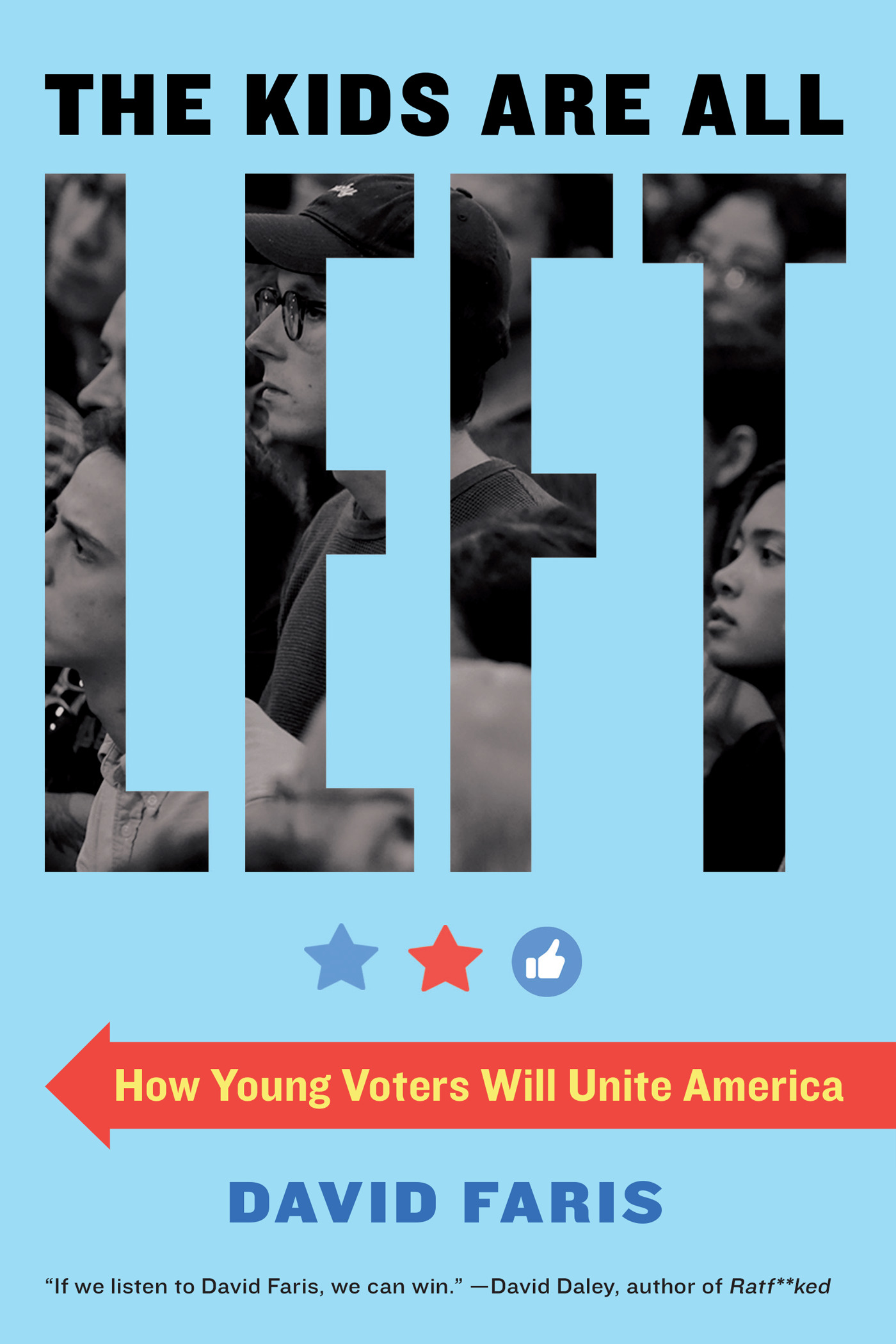
The Kids Are All Left A brewing generational shift to the Left is about to change politics—and our country—forever. A demographic apocalypse is coming for the Republican Party. Young voters overwhelmingly favor the Left, and the margins are at such an unprecedented and overwhelming scale that these voters are poised to end the partisan gridlock that has characterized politics for over thirty years. In The Kids Are All Left, political scientist David Faris proves beyond any doubt that this isn't just a typical generational trend that will even out over time and explores the policy transformations that young Americans will pursue. He offers hope for an escape from the political stalemate that has twice this century sent the loser of the popular vote to the White House, but he is realistic about the institutional obstacles that stand between voters and true majority rule. The result is a first look at America in the 21st century. POLITICAL SCIENCE,Political Process,Campaigns & Elections
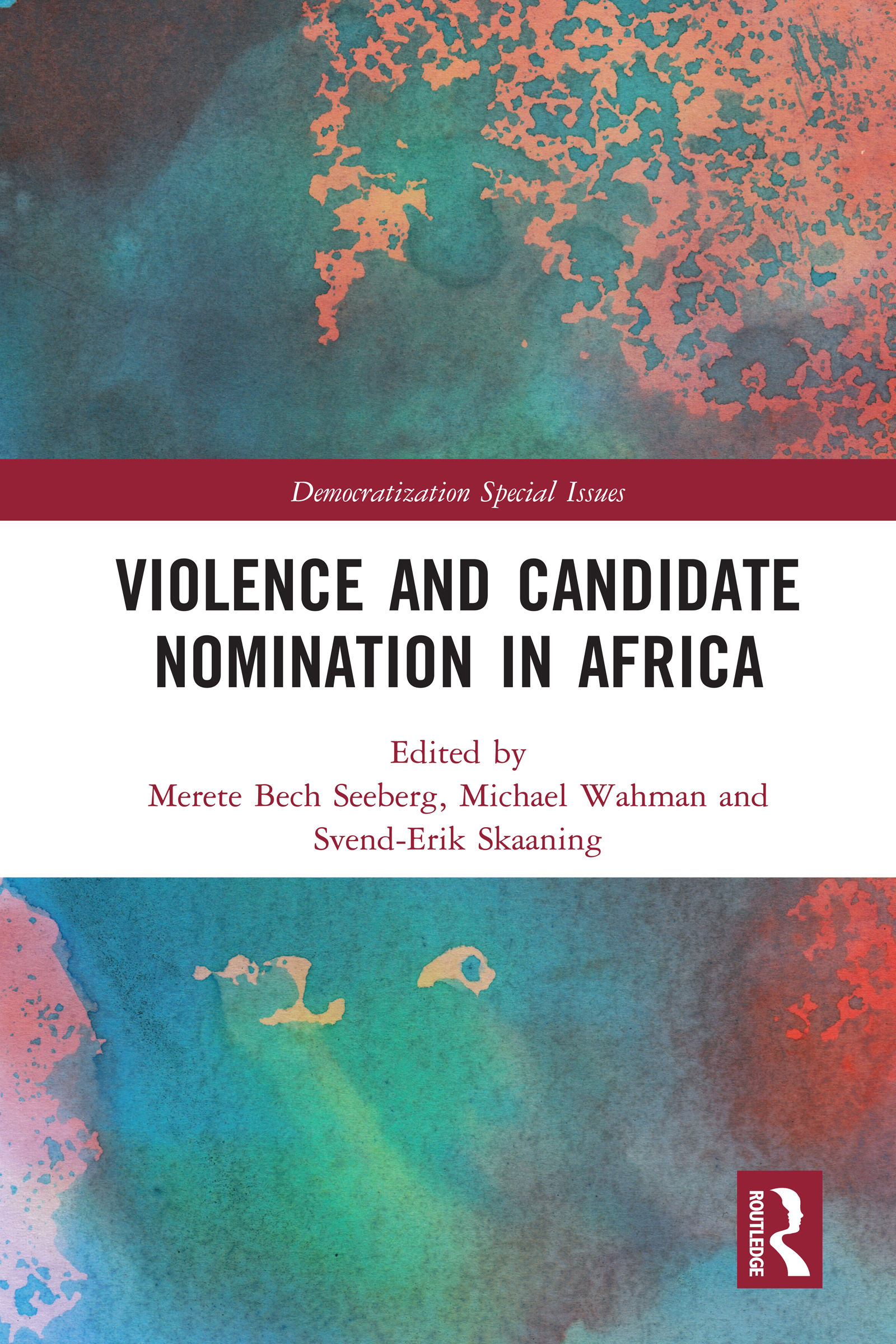
Violence and Candidate Nomination in Africa This comprehensive volume brings together a diverse set of scholars to analyse candidate nomination, intra-party democracy, and election violence in Africa. Through a combination of comparative studies and country-specific case studies spanning much of Sub-Saharan Africa, including Kenya, Zambia, and South Africa, the authors shed light on violence during candidate nomination processes within political parties. The book covers several cases that vary significantly in terms of democracy, party dominance and competitiveness, and the institutionalization and inclusiveness of candidate selection processes. The authors investigate how common violence is during candidate nomination processes; whether the drivers of nomination violence are identical to those of general election violence; whether nomination violence can be avoided in high risk cases such as dominant party regimes with fierce intra-party competition for power; and which subnational locations are most likely to experience nomination violence. Through its focus on violence in nomination processes, this book firmly places the role of political parties at the centre of the analysis of African election violence. While adding to our theoretical and empirical understanding of nomination violence, the book contributes to the literature on conflict, the literature on democratization and democratic consolidation, and the literature on African political parties. This book was originally published as a special issue of the journal Democratization. POLITICAL SCIENCE,Political Process,Campaigns & Elections
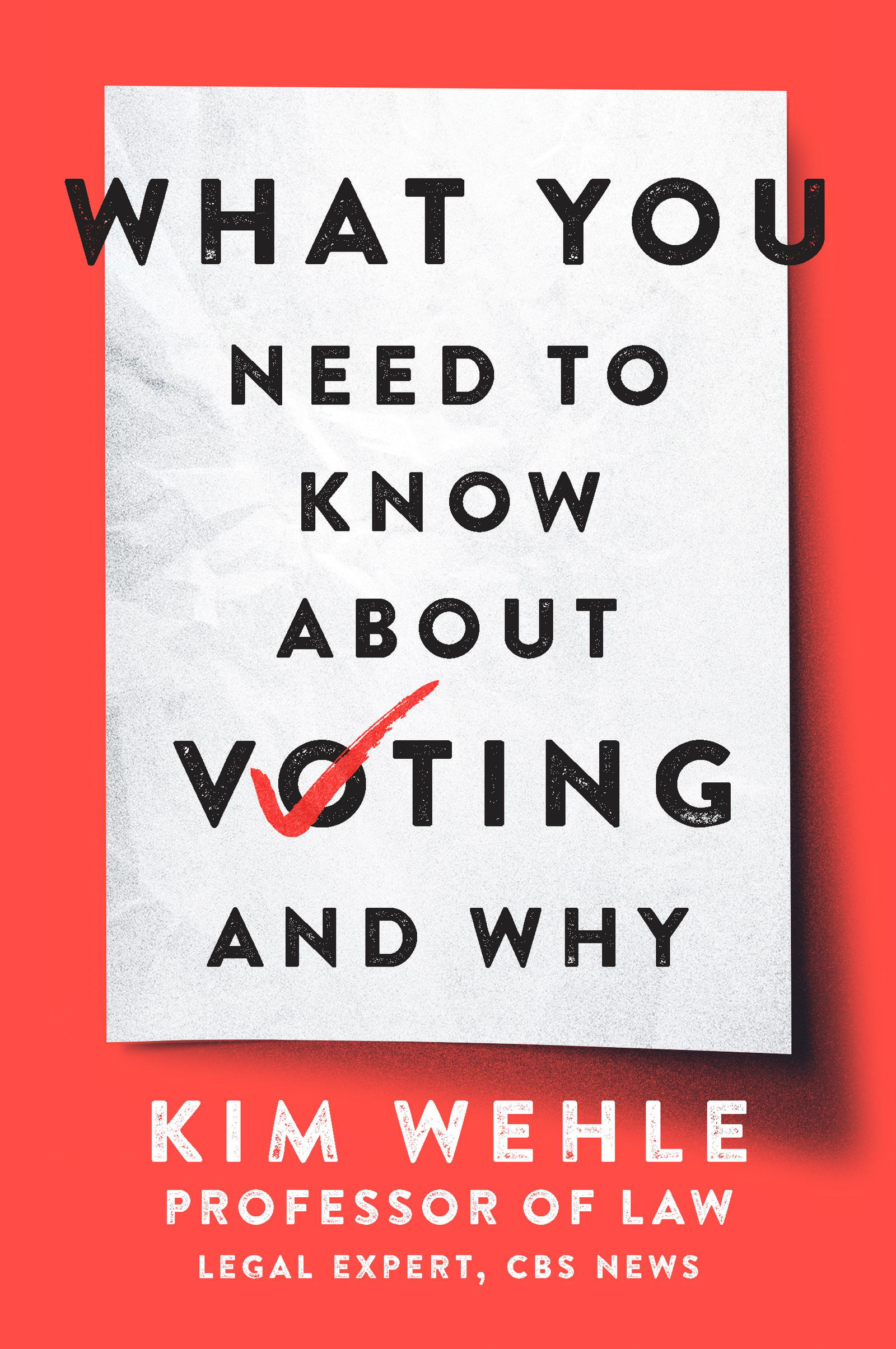
What You Need to Know About Voting--and Why Want to change the world? The first step is to exercise your right to vote! In this step by step guide, you can learn everything you need to know. In What You Need to Know About Voting—and Why, law professor and constitutional scholar Kimberly Wehle offers practical, useful advice on the mechanics of voting and an enlightening survey of its history and future. What is a primary? How does the electoral college work? Who gets to cast a ballot and why? How do mail-in ballots work? How do I register? For new voters, would-be voters, young people and all of us looking ahead to the next election, What You Need to Know About Voting—and Why is a timely and informative guide, providing the background you need in order to make informed choices that will shape our shared destiny for decades to come. POLITICAL SCIENCE,Political Process,Campaigns & Elections
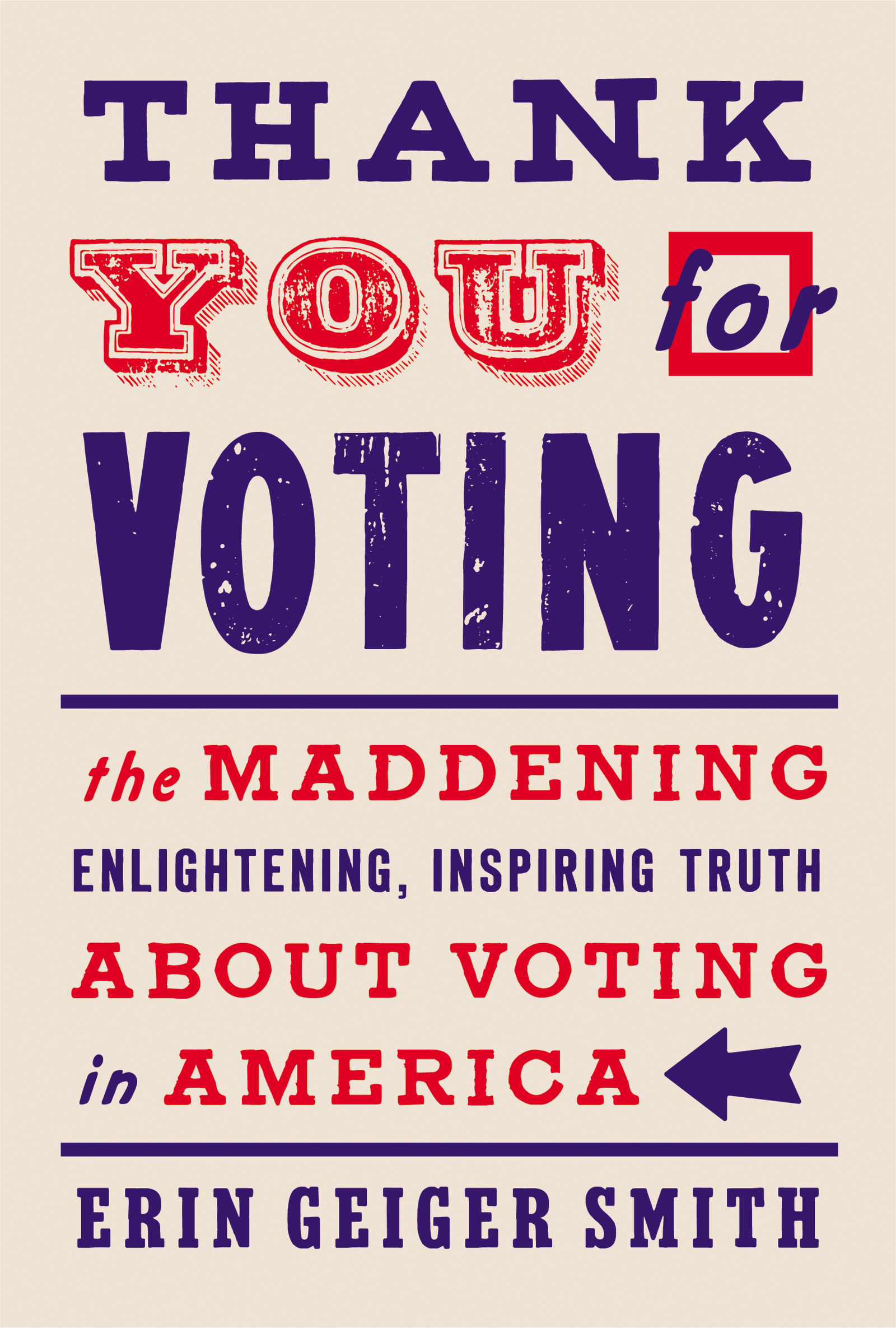
Thank You for Voting In this concise, lively look at the past, present, and future of voting, a journalist examines the long and continuing fight for voting equality, why so few Americans today vote, and innovative ways to educate and motivate them; included are checklists of what to do before election day to prepare to vote and encourage others. Voting is a prized American right and a topic of debate from the earliest days of the country. Yet in the 2016 presidential election, about 40 percent of Americans—and half of the country’s young adults—didn’t vote. Why do so many Americans choose not to vote, and what can we do about it? The problem, Erin Geiger Smith contends, is a lack of understanding about our electoral system and a need to make voting more accessible. Thank You for Voting is her eye-opening look at the voting process, starting with the Framers’ perspective, through the Equal Protection amendment and the Voting Rights Act, to the present and simple actions individuals can take to increase civic participation in local, state, and national elections. Geiger Smith expands our knowledge about our democracy—including women’s long fight to win the vote, attempts to suppress newly enfranchised voters' impact, state prohibitions against felons voting, charges of voter fraud and voter suppression, and other vital issues. In a conversational tone, she explains topics that can confuse even the most informed voters: polling, news literacy, gerrymandering and the Electoral College. She also explores how age, race, and socioeconomic factors influence turnout. Ultimately, Thank You for Voting offers hope. Geiger Smith challenges corporations to promote voting, and offers examples of how companies like Patagonia and Walmart have taken up the task in a non-partisan way. And she reveals how get-out-the-vote movements—such as television star Yara Shahidi’s voting organization, Michelle Obama’s When We All Vote campaign, and on-the-ground young activists—innovatively use technology and grassroots techniques to energize first-time voters. POLITICAL SCIENCE,Political Process,Campaigns & Elections
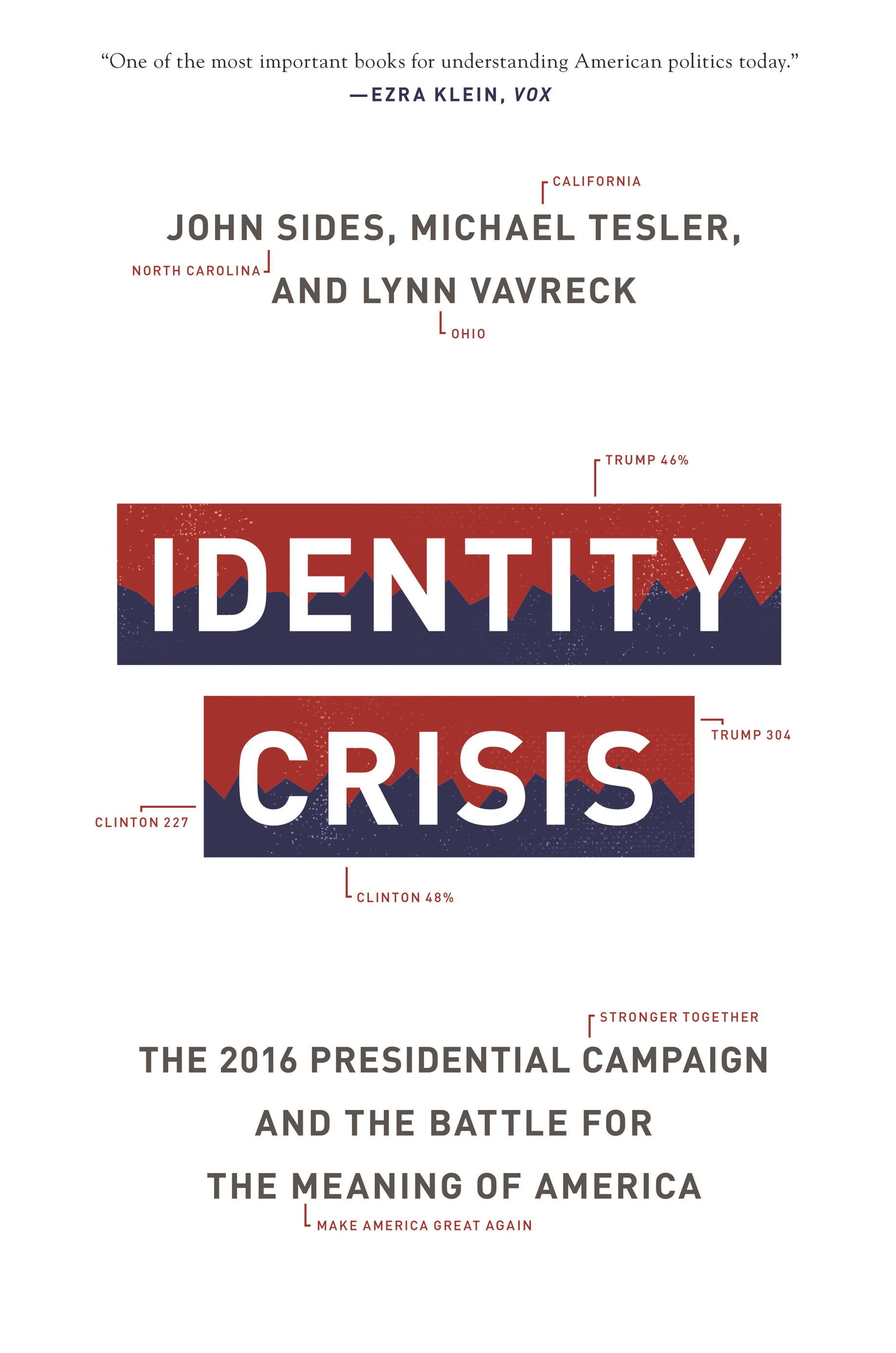
Identity Crisis A gripping in-depth look at the presidential election that stunned the world Donald Trump's election victory resulted in one of the most unexpected presidencies in history. Identity Crisis provides the definitive account of the campaign that seemed to break all the political rules—but in fact didn't. Featuring a new afterword by the authors that discusses the 2018 midterms and today's emerging political trends, this compelling book describes how Trump's victory was foreshadowed by changes in the Democratic and Republican coalitions that were driven by people's racial and ethnic identities, and how the Trump campaign exacerbated these divisions by hammering away on race, immigration, and religion. The result was an epic battle not just for the White House but about what America should be. POLITICAL SCIENCE,Political Process,Campaigns & Elections

Presidential Elections Polsby and Wildavsky’s classic text argues that the institutional rules of the presidential nomination and election processes, in combination with the behavior of the mass electorate, structure the strategic choices faced by politicians in powerful and foreseeable ways. POLITICAL SCIENCE,Political Process,Campaigns & Elections

Government by referendum Referendums are ubiquitous; from Brexit in the United Kingdom in 2016 to same-sex marriage in Australia in 2017 Why are referendums held at all? And when they are held, why are they won or lost? Moreover, what are the consequences of having referendums? Do they strengthen or weaken democracy? Are they mainly won or mainly lost or do they strengthen populist leaders? Or, are referendums a shield against demagogues and overeager politicians? Government by Referendum analyses why politicians sometime submit issues to the people Based on an historical analysis, but with an emphasis on the last two decades, the book shows that referendums often have been lost by powerful politicians. While sometimes used by autocrats, mechanisms of direct democracy have increasingly performed the function of democratic constitutional safeguards in developed democracies. POLITICAL SCIENCE,Political Process,Campaigns & Elections

The Making of the Presidential Candidates 2020 Exploring a wide range of issues including gender, money, media, voter coalitions, and the changing role of political parties, leading experts on American elections provide an indispensable guide to the 2020 presidential nomination process. POLITICAL SCIENCE,Political Process,Campaigns & Elections
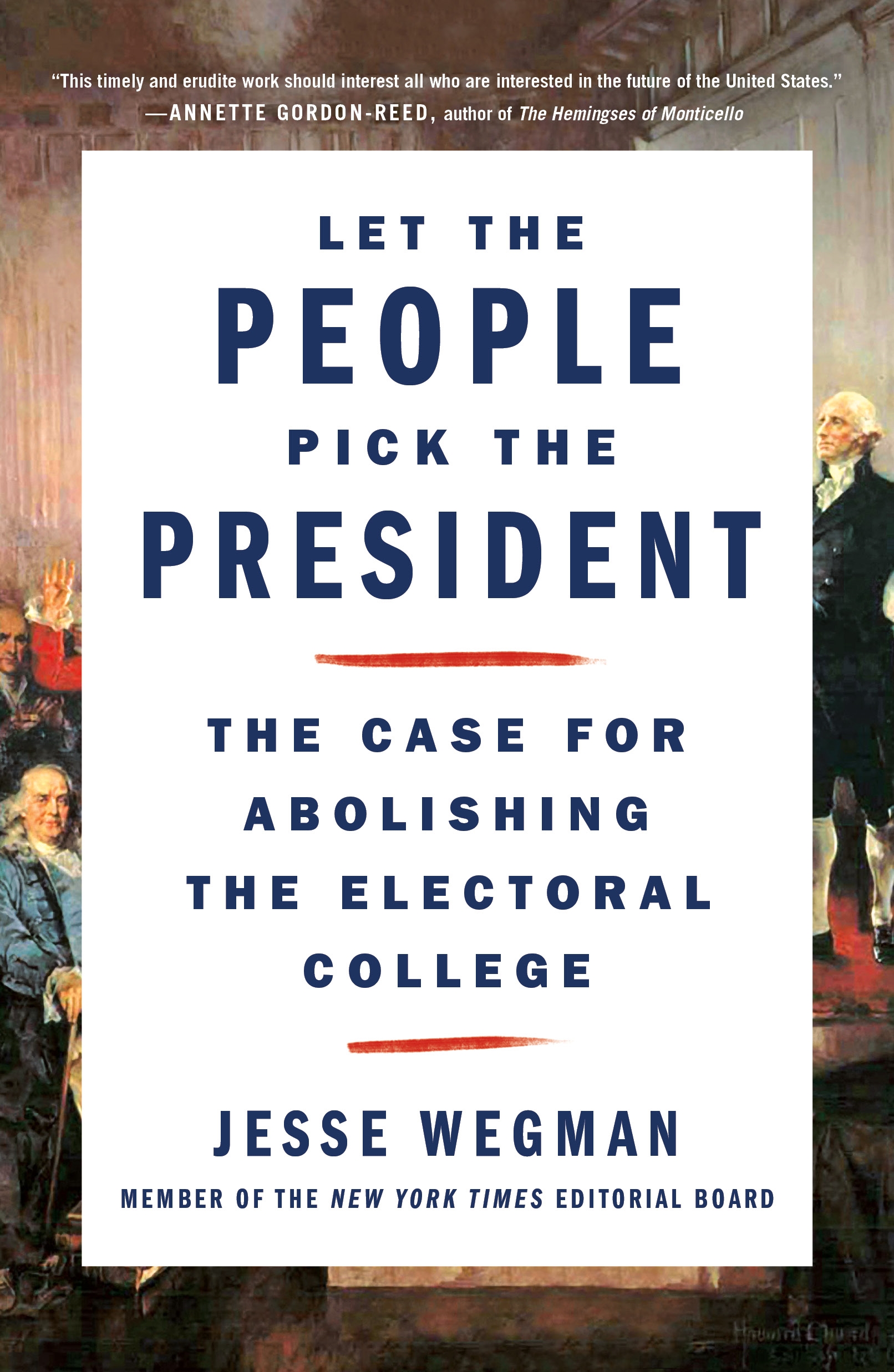
Let the People Pick the President “Wegman combines in-depth historical analysis and insight into contemporary politics to present a cogent argument that the Electoral College violates America’s ‘core democratic principles’ and should be done away with…" — Publishers Weekly The framers of the Constitution battled over it. Lawmakers have tried to amend or abolish it more than 700 times. To this day, millions of voters, and even members of Congress, misunderstand how it works. It deepens our national divide and distorts the core democratic principles of political equality and majority rule. How can we tolerate the Electoral College when every vote does not count the same, and the candidate who gets the most votes can lose? Twice in the last five elections, the Electoral College has overridden the popular vote, calling the integrity of the entire system into question—and creating a false picture of a country divided into bright red and blue blocks when in fact we are purple from coast to coast. Even when the popular-vote winner becomes president, tens of millions of Americans—Republicans and Democrats alike—find that their votes didn't matter. And, with statewide winner-take-all rules, only a handful of battleground states ultimately decide who will become president. Now, as political passions reach a boiling point at the dawn of the 2020 race, the message from the American people is clear: The way we vote for the only official whose job it is to represent all Americans is neither fair nor just. Major reform is needed—now. Isn't it time to let the people pick the president? In this thoroughly researched and engaging call to arms, Supreme Court journalist and New York Times editorial board member Jesse Wegman draws upon the history of the founding era, as well as information gleaned from campaign managers, field directors, and other officials from twenty-first-century Democratic and Republican presidential campaigns, to make a powerful case for abolishing the antiquated and antidemocratic Electoral College. In Let the People Pick the President he shows how we can at long last make every vote in the United States count—and restore belief in our democratic system. POLITICAL SCIENCE,Political Process,Campaigns & Elections
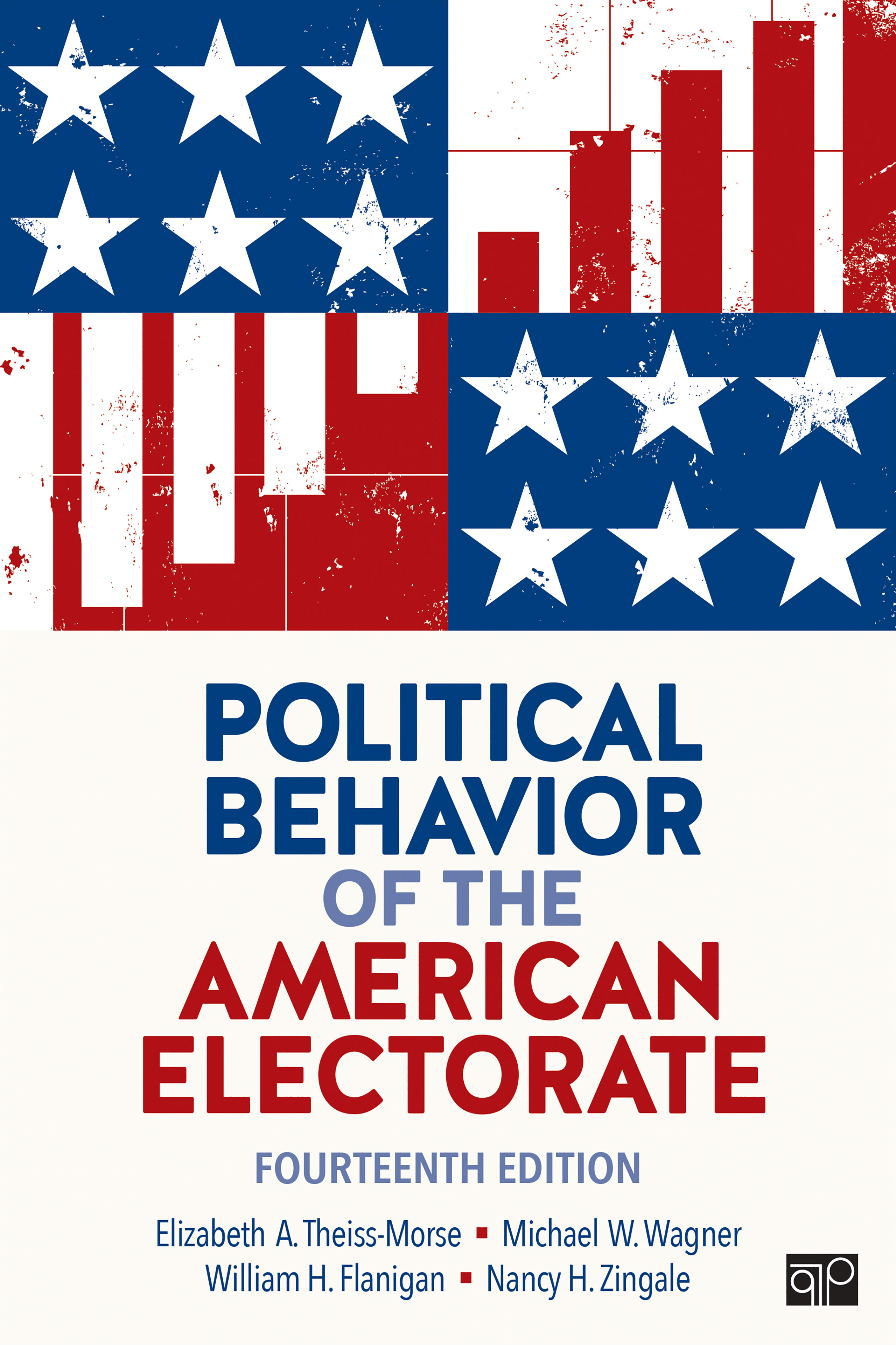
Political Behavior of the American Electorate The 2016 elections took place under intense political polarization and uncertain economic conditions, to widely unexpected results. How did Trump pull off his victory? Political Behavior of the American Electorate , Fourteenth Edition, attempts to answer this question by interpreting data from the most recent American National Election Study to provide a thorough analysis of the 2016 elections and the current American political behavior. Authors Elizabeth Theiss-Morse and Michael Wagner continue the tradition of Flanigan and Zingale to illustrate and document trends in American political behavior with the best longitudinal data available. The authors also put these trends in context by focusing on the major concepts and characteristics that shape Americans’ responses to politics. In the completely revised Fourteenth Edition, you will explore get-out-the-vote efforts and the reasons people voted the way they did, as well as the nature and impact of partisanship, news media coverage, and other issues in 2016—all with an eye toward understanding the trends that led up to the historic decision. POLITICAL SCIENCE,Political Process,Campaigns & Elections
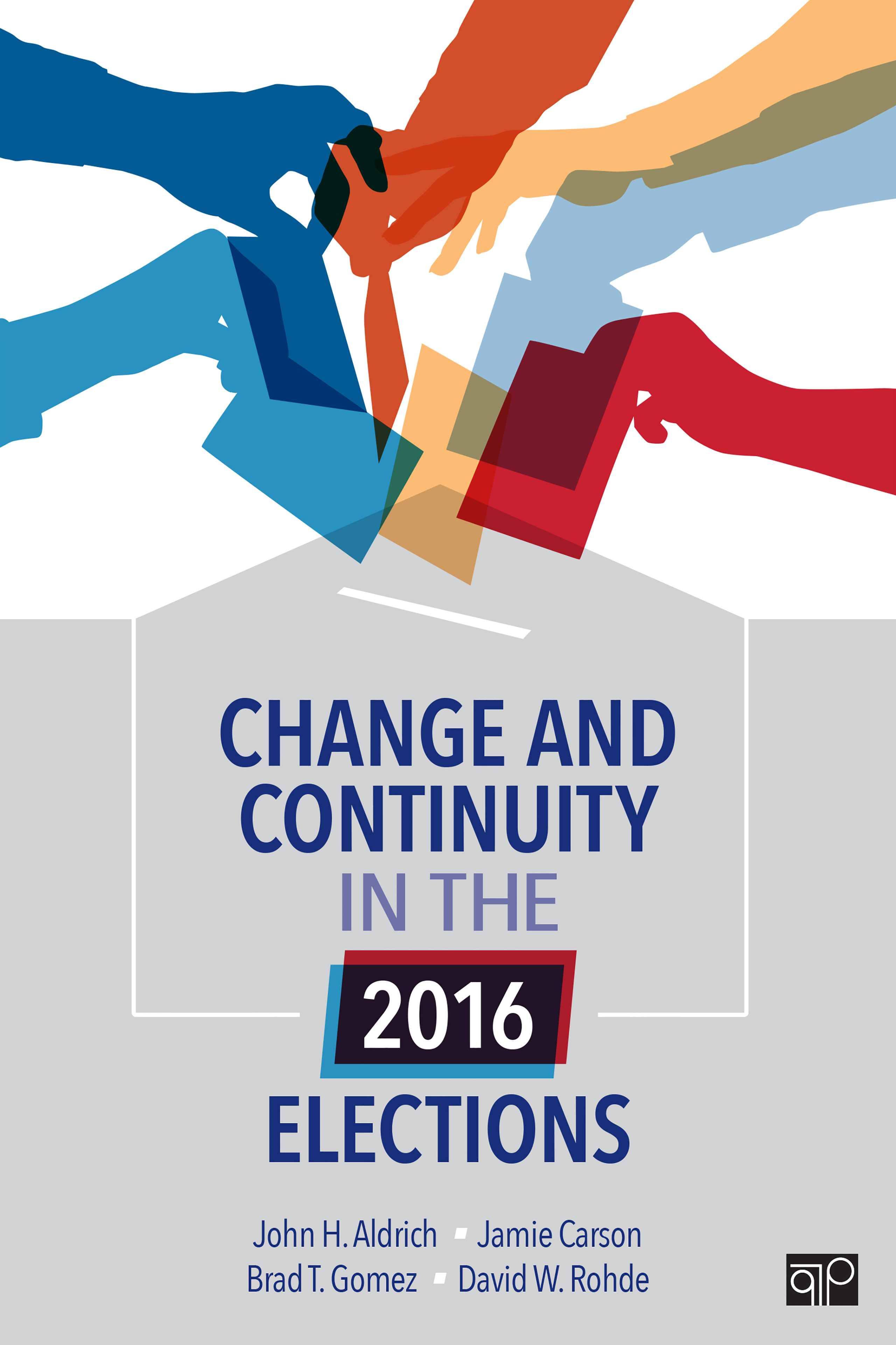
Change and Continuity in the 2016 Elections Is America in the midst of an electoral transformation? What were the sources of Trump’s victory in 2016, and how do they differ from Republican coalitions of the past? Does his victory signal a long-term positive trajectory for Republicans’ chances in presidential elections? Change and Continuity in the 2016 Elections attempts to answer those questions by analyzing and explaining the voting behavior in the most recent election, as well as setting the results in the context of larger trends and patterns in elections studies. New co-author Jamie L. Carson brings years of congressional and election research experience to help this top-notch author team meticulously explain the latest National Election Studies data and discuss its importance and impact. You will critically analyze a variety of variables such as the presidential and congressional elections, voter turnout, and the social forces, party loyalties, and prominent issues that affect voting behavior. You will also walk away with a better understanding of this groundbreaking election and what those results mean for the future of American politics. POLITICAL SCIENCE,Political Process,Campaigns & Elections

Inside Campaigns Take your students on a journey into the world of campaign managers. Powered by scores of interviews and surveys of political professionals, the book considers the purpose, potency, and poetry of modern political campaigns in the US. POLITICAL SCIENCE,Political Process,Campaigns & Elections

Congressional Elections Paul Herrnson's popular book argues that successful candidates run two campaigns: one for votes, the other for resources. Using campaign finance data, original survey research, and hundreds of interviews with candidates and political insiders, Congressional Elections looks at how this dual strategy affects who wins and, ultimately, the entire electoral system. The Eighth Edition, now with now with noted scholar Costas Panagopoulos joining as co-author, considers the full impact of recent trends in social media, campaign finance, the role of outside groups, and new voting processes on candidate, party, and voter mobilization tactics. POLITICAL SCIENCE,Political Process,Campaigns & Elections

Trump and the American Future In this insightful call to action, New York Times bestselling author Newt Gingrich explains what is at stake in the 2020 elections -- and why Donald Trump must be re-elected. The 2020 election will be a decisive choice for America, especially as we emerge from the coronavirus crisis. Will the American people choose four more years of President Trump to lead us back to strong economic growth, a foreign and trade policy of putting American interests first, dismantling the deep state, and dramatically reforming the bureaucracies? Or will they reject Trumpism and elect the radical Democratic policies of big government, globalism, and socialist policies that Joe Biden represents? Not since the election of 1964 has the choice in an election been so stark. Trump and the American Future by Newt Gingrich will lay out the stakes of the 2020 election and provide a clarion call for all Americans on why it is vital to return President Trump to the White House for a second term. Featuring insights gleaned from the lifetime of experience and access only Newt Gingrich can bring, Trump and the American Future will be crucial reading for every citizen who wants to continue to make America great again. POLITICAL SCIENCE,Political Process,Campaigns & Elections

Liar's Circus "A brilliant, riveting, funny, terrifying journey into the beating heart of Trumpland." —Liza Mundy, author of Code Girls In this daring work of immersive journalism, based on hundreds of hours of reporting, Carl Hoffman journeys deep inside Donald Trump’s rallies, seeking to understand the strange and powerful tribe that forms the president’s base. Hoffman, who has written about the most dangerous and remote corners of the world, pierced this alternate society, welcomed in and initiated into its rites and upside-down beliefs, and finally ushered to its inner sanctum. Equally freewheeling and profound, Liar’s Circus tracks the MAGA faithful across five thousand miles of the American heartland during a crucial arc of the Trump presidency stretching from the impeachment saga to the dawn of the coronavirus pandemic that ended the rallies as we know it. Trump’s rallies are a singular and defining force in American history—a kind of Rosetta stone to understanding the Age of Trump. Yet while much remarked upon, they are, in fact, little examined, with the focus almost always on Trump’s latest outrageous statement. But who are the tens of thousands of people who fill these arenas? What do they see in Trump? And what curious alchemy—between president and adoring crowd—happens there that might explain Trump’s rise and powerful hold over both his base and the GOP? To those on the left, the rallies are a Black Mass of American politics at which Trump plays high priest, recklessly summoning the darkest forces within the nation. To the MAGA faithful, the rallies are a form of pilgrimage, a joyous ceremony that like all rituals binds people together and makes them feel a part of something bigger than themselves. Both sides would acknowledge that this traveling roadshow is the pressurized, combustible core of Trump’s political power, a meeting of the faithful where Trump is unshackled and his rhetoric reaches its most extreme, with downstream consequences for the rest of the nation. To date, no reporter has sought to understand the rallies as a sociological phenomenon examined from the bottom up. Hoffman has done just this. He has stood in line for more than 170 hours with Trump's most ardent superfans and joined them at the very front row; he has traveled from Minnesota to Texas, Louisiana, Mississippi, and New Hampshire immersing himself in their culture. Liar’s Circus is a revelatory portrait of Trump’s America, from one of our most intrepid journalists. POLITICAL SCIENCE,Political Process,Campaigns & Elections
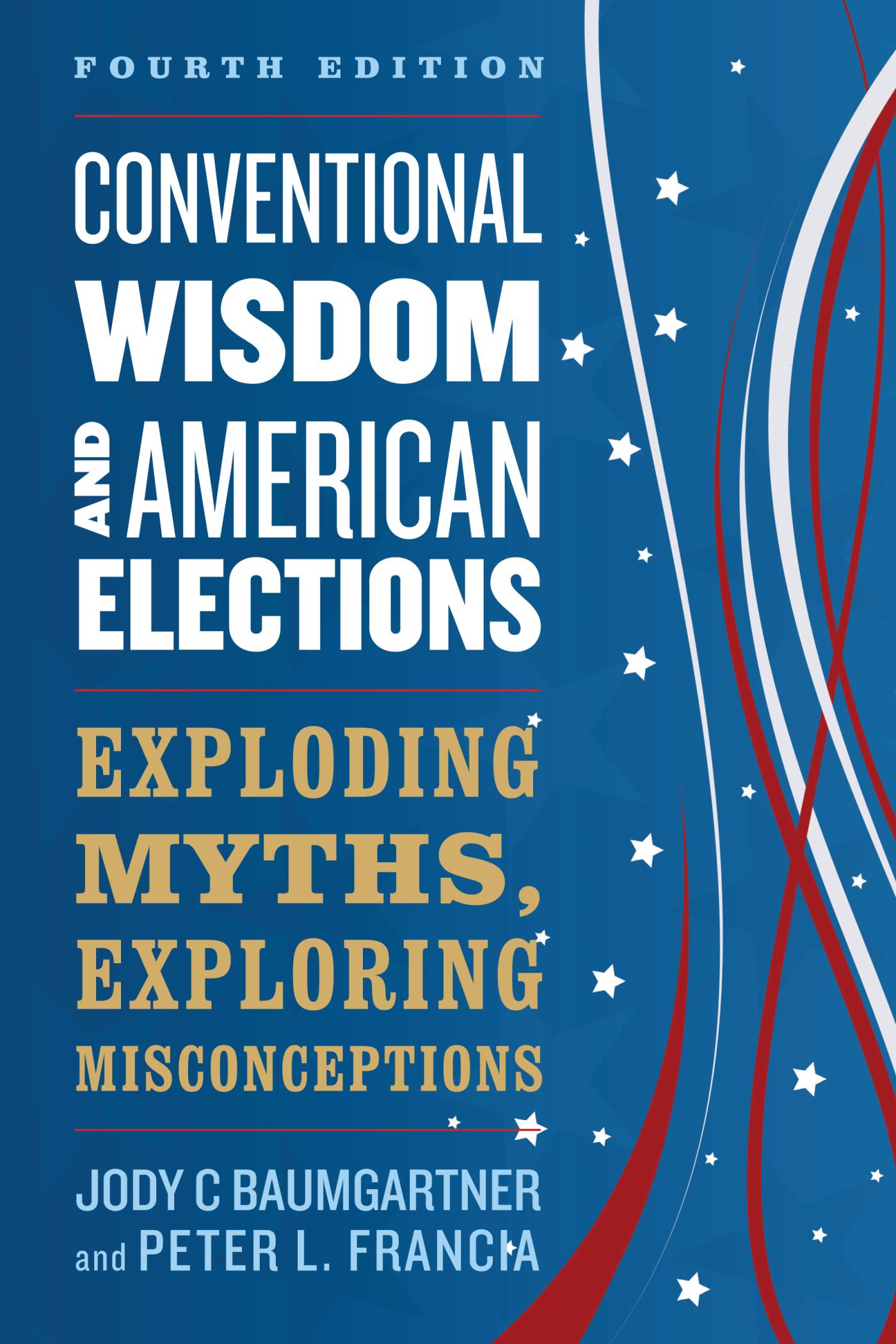
Conventional Wisdom and American Elections Many Americans develop misinformed opinions about the U.S. electoral process. Conventional Wisdom and American Elections debunks common misunderstandings that have arisen about the electoral process in the past few decades. This book engages readers in elections, and teaches them to evaluate information like a political scientist. POLITICAL SCIENCE,Political Process,Campaigns & Elections
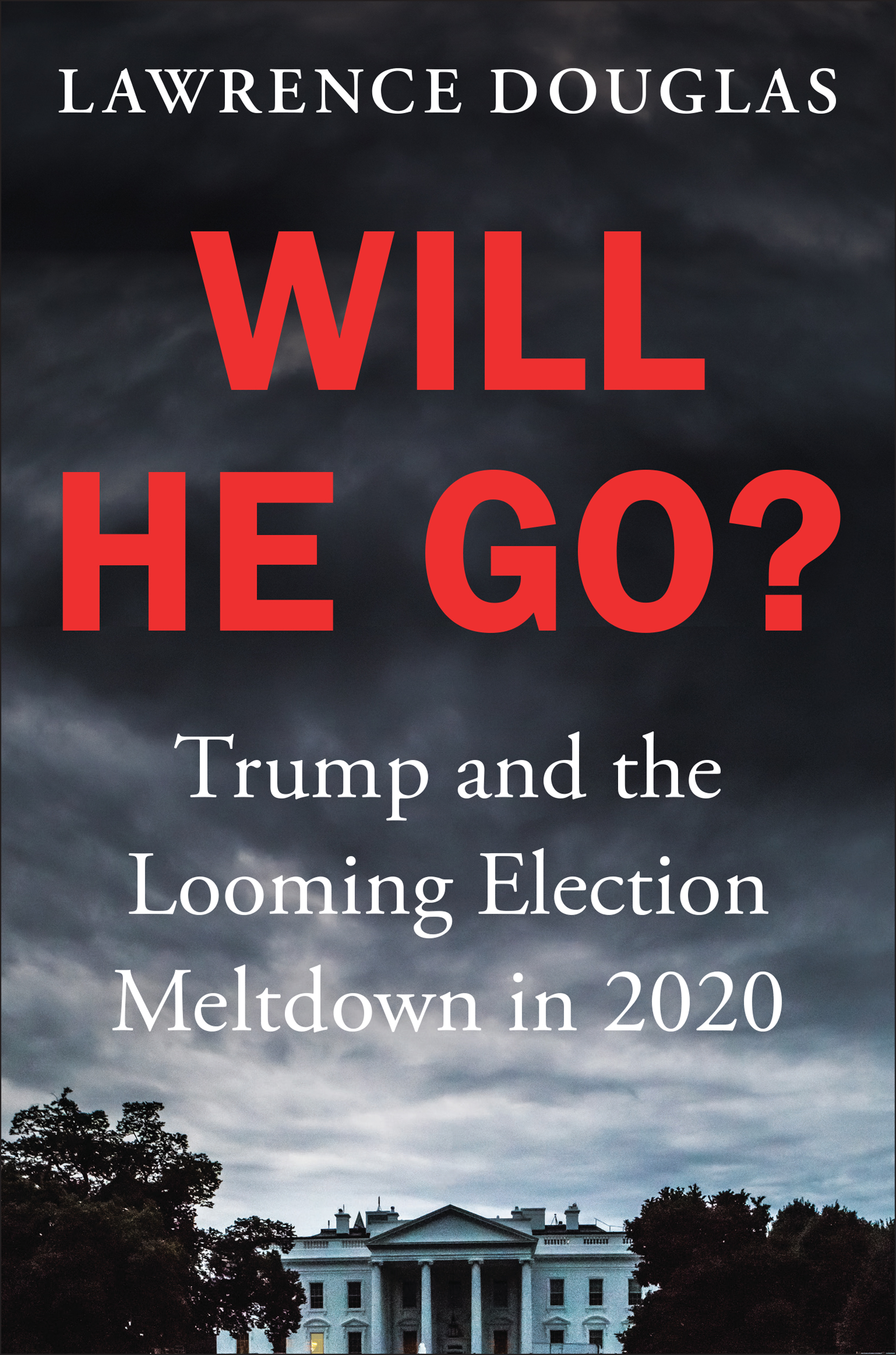
Will He Go? In advance of the 2020 election, legal scholar Lawrence Douglas prepares readers for a less-than-peaceful transition of power. It doesn't require a strong imagination to get a sense of the mayhem Trump will unleash if he loses a closely contested election. It is no less disturbing to imagine Trump still insisting that he is the rightful leader of the nation. With millions of diehard supporters firmly believing that their revered president has been toppled by malignant forces of the Deep State, Trump could remain a force of constitutional chaos for years to come. WILL TRUMP GO? addresses such questions as: How might Trump engineer his refusal to acknowledge electoral defeat? What legal and extra-legal paths could he pursue in mobilizing a challenge to the electoral outcome? What legal, political, institutional, and popular mechanisms can be used to stop him? What would be the fallout of a failure to remove him from office? What would be the fallout of a successful effort to unseat him? Can our democracy snap back from Trump? Trump himself has essentially told the nation he will never accept electoral defeat. A book that prepares us for Trump's refusal to concede, then, is hardly speculative; it is a necessary precaution against a coming crisis. POLITICAL SCIENCE,Political Process,Campaigns & Elections
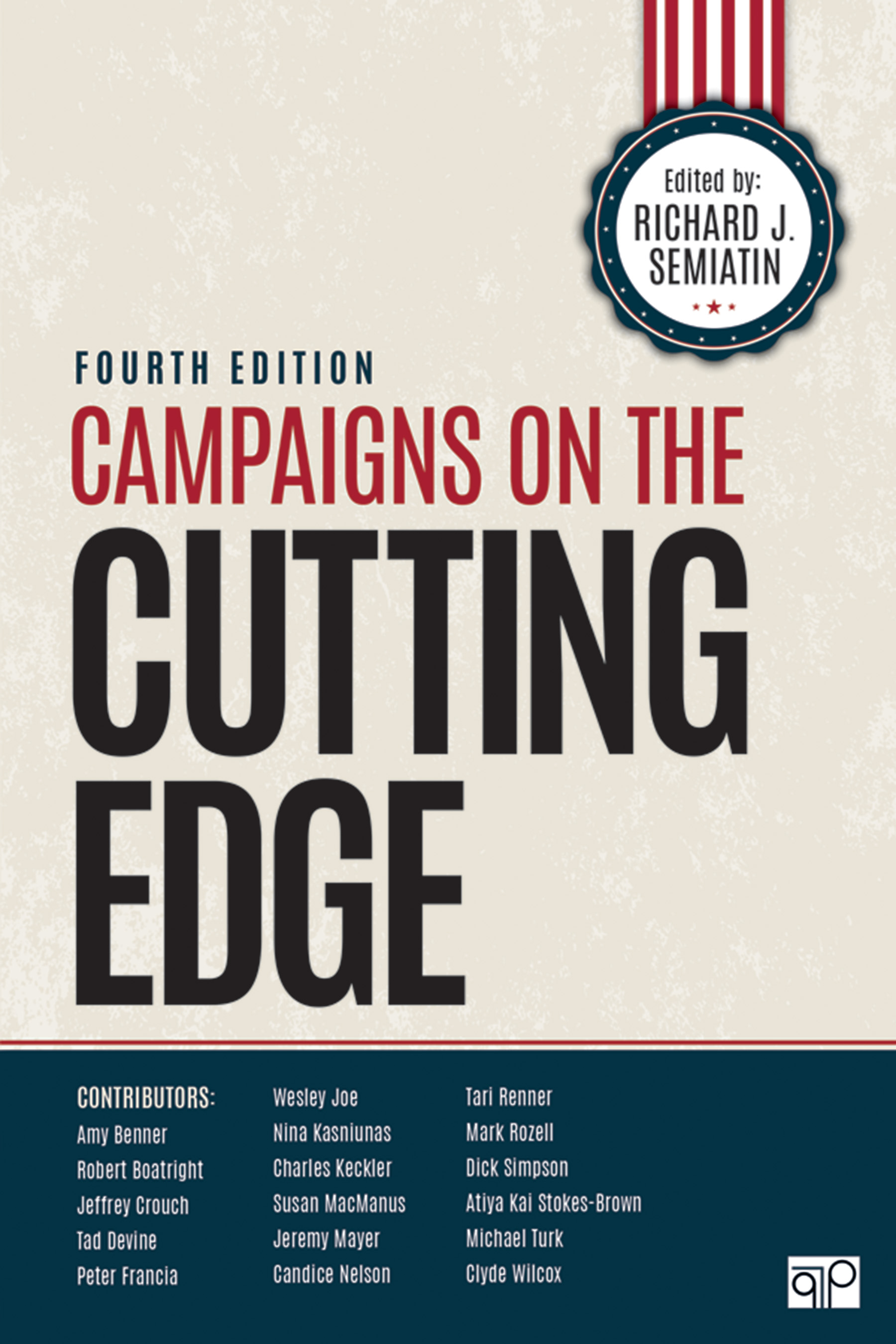
Campaigns on the Cutting Edge Technology now allows candidates to announce their candidacies online, raise money through web fundraising, and mobilize supporters via smartphones. These increasingly mobile and integrated campaigns face the growing influence of outside interests. Evaluate current trends and assess how campaigns are making cutting-edge changes on the presidential, congressional, and gubernatorial levels with Campaigns on the Cutting Edge. The thoroughly updated fourth edition focuses on the use of social media and online surveying tools in campaigns, the evolution of voter mobilization, the growth of "fake news," and the increased representation of women, African Americans, Latino Americans, and Asian Americans not only in the electoral force, but also in the campaign organization. POLITICAL SCIENCE,Political Process,Campaigns & Elections

Inside the Mind of a Voter An in-depth look into the psychology of voters around the world, how voters shape elections, and how elections transform citizens and affect their lives Could understanding whether elections make people happy and bring them closure matter more than who they vote for? What if people did not vote for what they want but for what they believe is right based on roles they implicitly assume? Do elections make people cry? This book invites readers on a unique journey inside the mind of a voter using unprecedented data from the United States, the United Kingdom, Germany, France, South Africa, and Georgia throughout a period when the world evolved from the centrist dominance of Obama and Mandela to the shock victories of Brexit and Trump. Michael Bruter and Sarah Harrison explore three interrelated aspects of the heart and mind of voters: the psychological bases of their behavior, how they experience elections and the emotions this entails, and how and when elections bring democratic resolution. The authors examine unique concepts including electoral identity, atmosphere, ergonomics, and hostility. From filming the shadow of voters in the polling booth, to panel study surveys, election diaries, and interviews, Bruter and Harrison unveil insights into the conscious and subconscious sides of citizens’ psychology throughout a unique decade for electoral democracy. They highlight how citizens’ personality, memory, and identity affect their vote and experience of elections, when elections generate hope or hopelessness, and how subtle differences in electoral arrangements interact with voters’ psychology to trigger different emotions. Inside the Mind of a Voter radically shifts electoral science, moving away from implicitly institution-centric visions of behavior to understand elections from the point of view of voters. POLITICAL SCIENCE,Political Process,Campaigns & Elections

Our Time Is Now NEW YORK TIMES BESTSELLER "With each page, she inspires and empowers us to create systems that reflect a world in which all voices are heard and all people believe and feel that they matter." —Kerry Washington "This is a narrative that describes the urgency that compels me and millions more to push for a different American story than the one being told today. It's a story that is one part danger, one part action, and all true. It's a story about how and why we fight for our democracy and win." —Stacey Abrams Celebrated national leader and bestselling author Stacey Abrams offers a blueprint to end voter suppression, empower our citizens, and take back our country. A recognized expert on fair voting and civic engagement, Abrams chronicles a chilling account of how the right to vote and the principle of democracy have been and continue to be under attack. Abrams would have been the first African American woman governor, but experienced these effects firsthand, despite running the most innovative race in modern politics as the Democratic nominee in Georgia. Abrams didn’t win, but she has not conceded. The book compellingly argues for the importance of robust voter protections, an elevation of identity politics, engagement in the census, and a return to moral international leadership. Our Time Is Now draws on extensive research from national organizations and renowned scholars, as well as anecdotes from her life and others’ who have fought throughout our country’s history for the power to be heard. The stakes could not be higher. Here are concrete solutions and inspiration to stand up for who we are—now. POLITICAL SCIENCE,Political Process,Campaigns & Elections
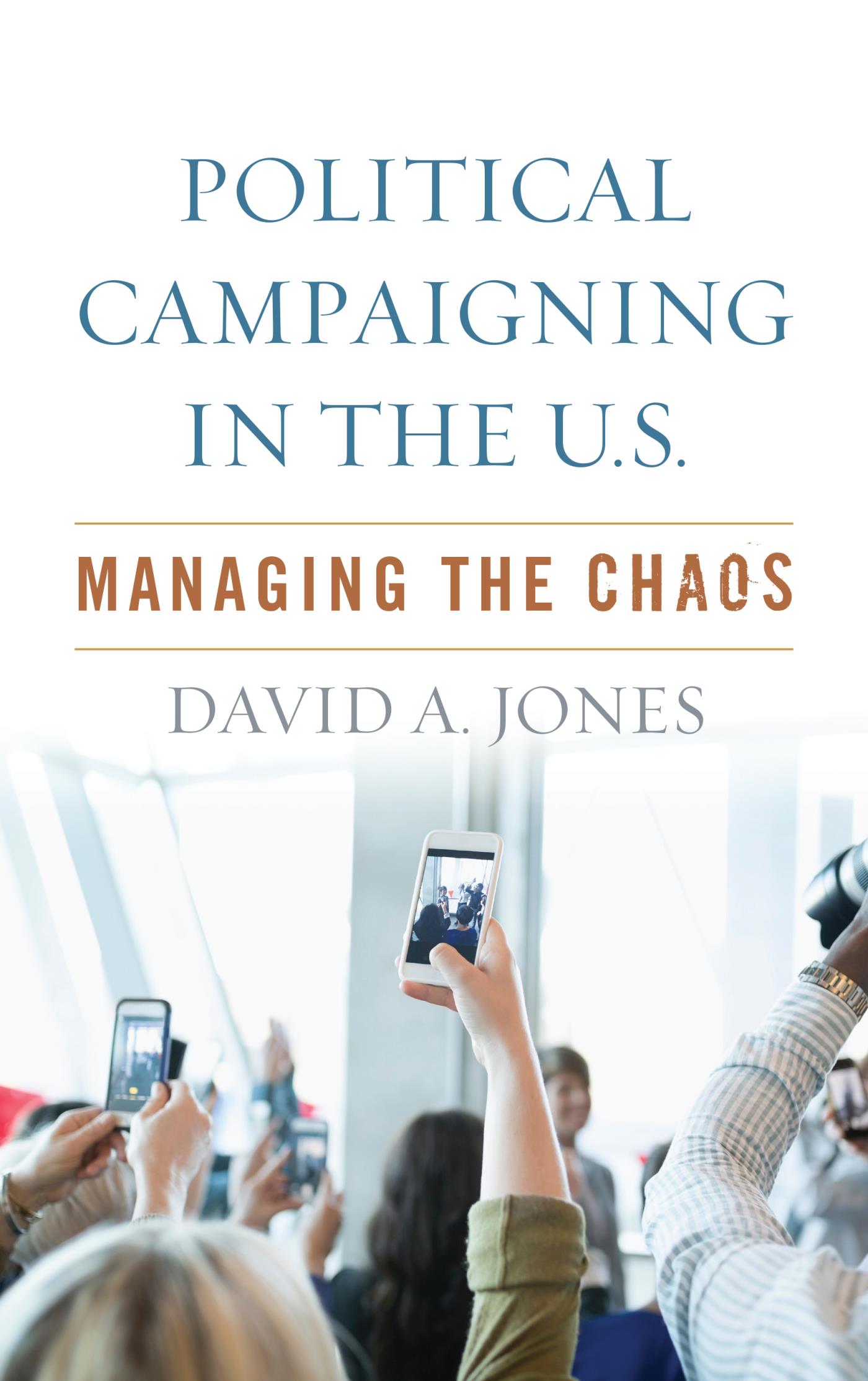
Political Campaigning in the U.S. The purpose of Political Campaigning in the U.S.: Managing Chaos is to provide readers with a comprehensive yet concise and accessible overview of modern election campaign practices. POLITICAL SCIENCE,Political Process,Campaigns & Elections
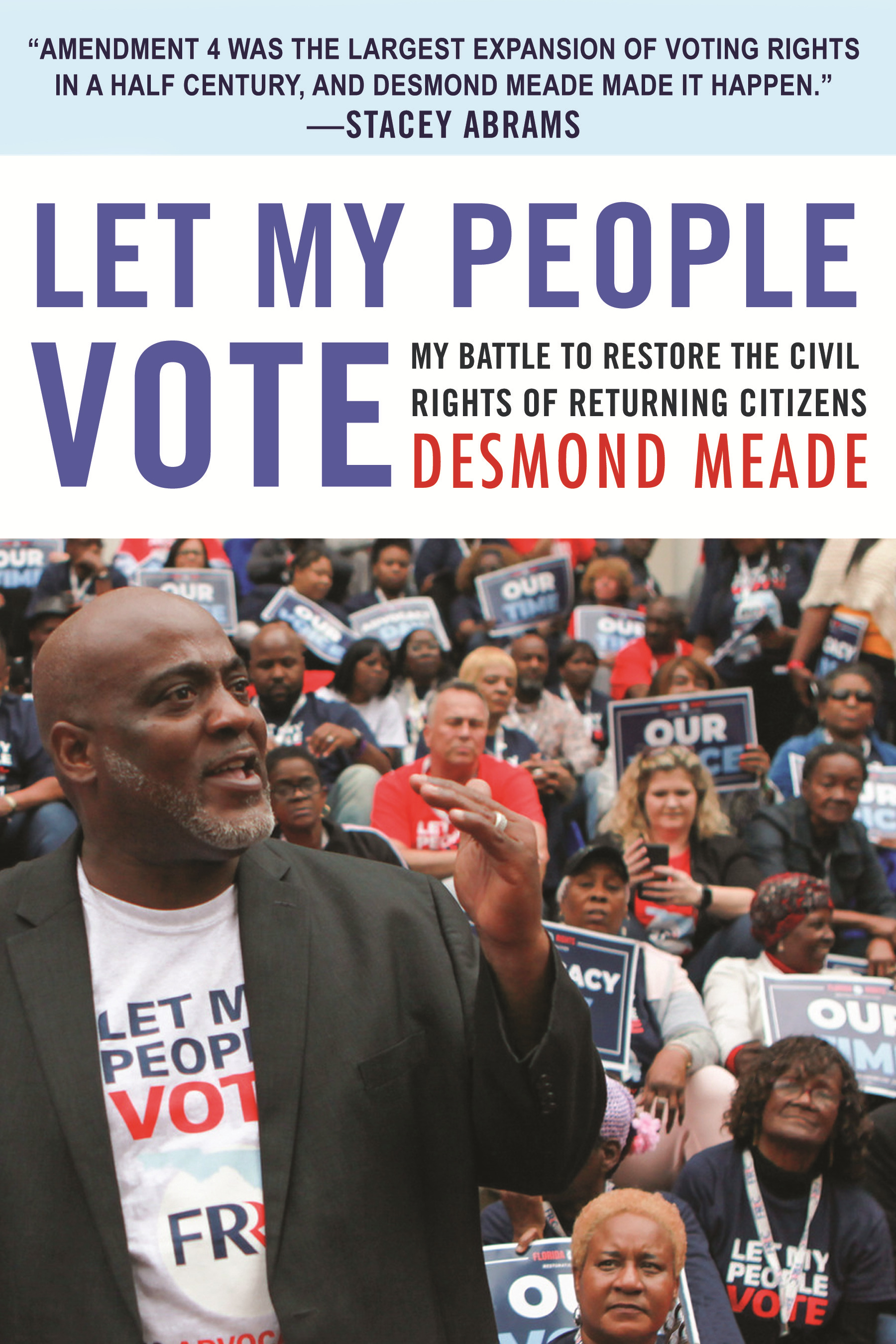
Let My People Vote The inspiring and eye-opening true story of one man’s undying belief in the power of a fully enfranchised nation. “You may think the right to vote is a small matter, and if you do, I would bet you have never had it taken away from you.” Thus begins the story of Desmond Meade and his inspiring journey to restore voting rights to roughly 1.4 million returning citizens in Florida—resulting in a stunning victory in 2018 that enfranchised the most people at once in any single initiative since women’s suffrage. Let My People Vote is the deeply moving, personal story of Meade’s life, his political activism, and the movement he spearheaded to restore voting rights to returning citizens who had served their terms. Meade survived a tough childhood only to find himself with a felony conviction. Finding the strength to pull his life together, he graduated summa cum laude from college, graduated from law school, and married. But because of his conviction, he was not even allowed to sit for the bar exam in Florida. And when his wife ran for state office, he was filled with pride—but not permitted to vote for her. Meade takes us on a journey from his time in homeless shelters, to the exhilarating, joyful night in November of 2018, when Amendment 4 passed with 65 percent of the vote. Meade’s story, and his commitment to a fully enfranchised nation, will prove to readers that one person really can make a difference. POLITICAL SCIENCE,Political Process,Campaigns & Elections

The Populist's Guide to 2020 Krystal Ball and Saagar Enjeti are co-hosts of Rising at The Hill TV, one of the fastest growing political shows in America. Theirs is the only book that fuses the populist right and populist left to explain the rise of the Trump and Sanders movements. The authors curate an essential collection of their biting commentary, stunning predictions, media critiques, and reveal their vision for a working class centered politics. No establishment media or political figure goes unscathed. This book reveals the white hot core of The Hill Rising’s meteoric rise in the alternative media space. We are living through chaotic, nerve-wracking, and occasionally terrifying times, but we hope you will find this book both hopeful and helpful. Nothing has made us more hopeful than our work together on Rising, watching what unfolds, laughing at the absurdities, and joining in our outrage at the often bipartisan rituals of manipulating our fellow citizens and viewing them with contempt. People are often confused by our politics and how much we end up in agreement. Ultimately, we have largely different policy prescriptions and beliefs. However, we do share a central diagnosis of the rot in this country, of how we got to this place, and a deep skepticism of power. It’s amazing how far you can get when you start in the same place with a shared understanding of reality. It’s a hell of a lot further than the shallow, fake civility politics that the forces of the status-quo say you must embrace-‘Keep quiet and hold still while they rip you to shreds.’ We take the opposite view. Speak up. Make people uncomfortable. Don’t let the “experts†convince you that better isn’t possible. POLITICAL SCIENCE,Political Process,Campaigns & Elections
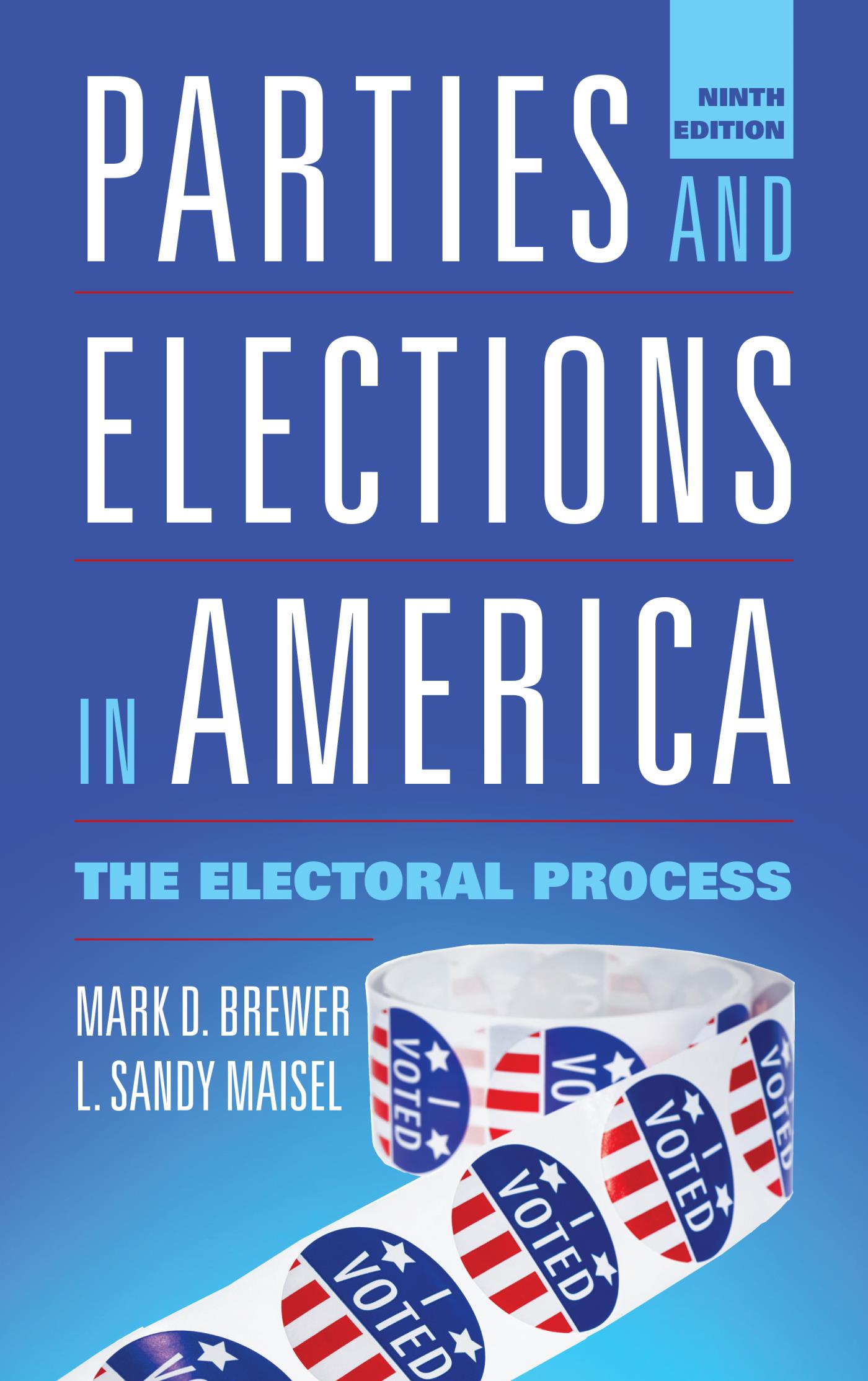
Parties and Elections in America This classic text provides an in-depth examination and history of American political parties and their critical role in representative democracy at the local, state, and national levels. POLITICAL SCIENCE,Political Process,Campaigns & Elections

You're Fired “You’re fired!†Donald Trump became famous bellowing those words in a make-believe boardroom. In November, tens of millions of Americans want to yell it right back at him. Yet Trump has seemed to almost defy the laws of political physics. Paul Begala, one of America’s greatest political talents, lays out the strategy that will defeat him and send him and his industrial-strength spray-on tan machine back to Mar-a-Lago. In You’re Fired, Paul Begala tells us how Trump uses division to distract from the actual reality of his record. Distraction, he argues, is Trump’s superpower. And this book is Kryptonite. In it, the man who helped elect Bill Clinton and reelect Barack Obama, details: -The special weapons and tactics needed in the unconventional war against this most unconventional politician -How to drive a wedge—or, rather, a pickup truck—between Trump and many of his supporters, especially blue-collar workers and farmers -Where the votes to defeat Trump will come from, and how the Rising American Electorate can catch Trump flat-footed -How Democrats can run on issues ranging from Coronavirus and healthcare to the economy, as well as climate change and Trump’s long-term plan to dominate the federal judiciary -There is one chapter called simply, “This Chapter Will Beat Trump.†Find out why Begala is so confident and what issue he says will sink the Trumptanic Full of memorable advice and Begala’s trademark wit, You’re Fired focuses on the lessons we can learn from the party’s successes and failures—and the crucial tools Democrats need to beat Trump. POLITICAL SCIENCE,Political Process,Campaigns & Elections
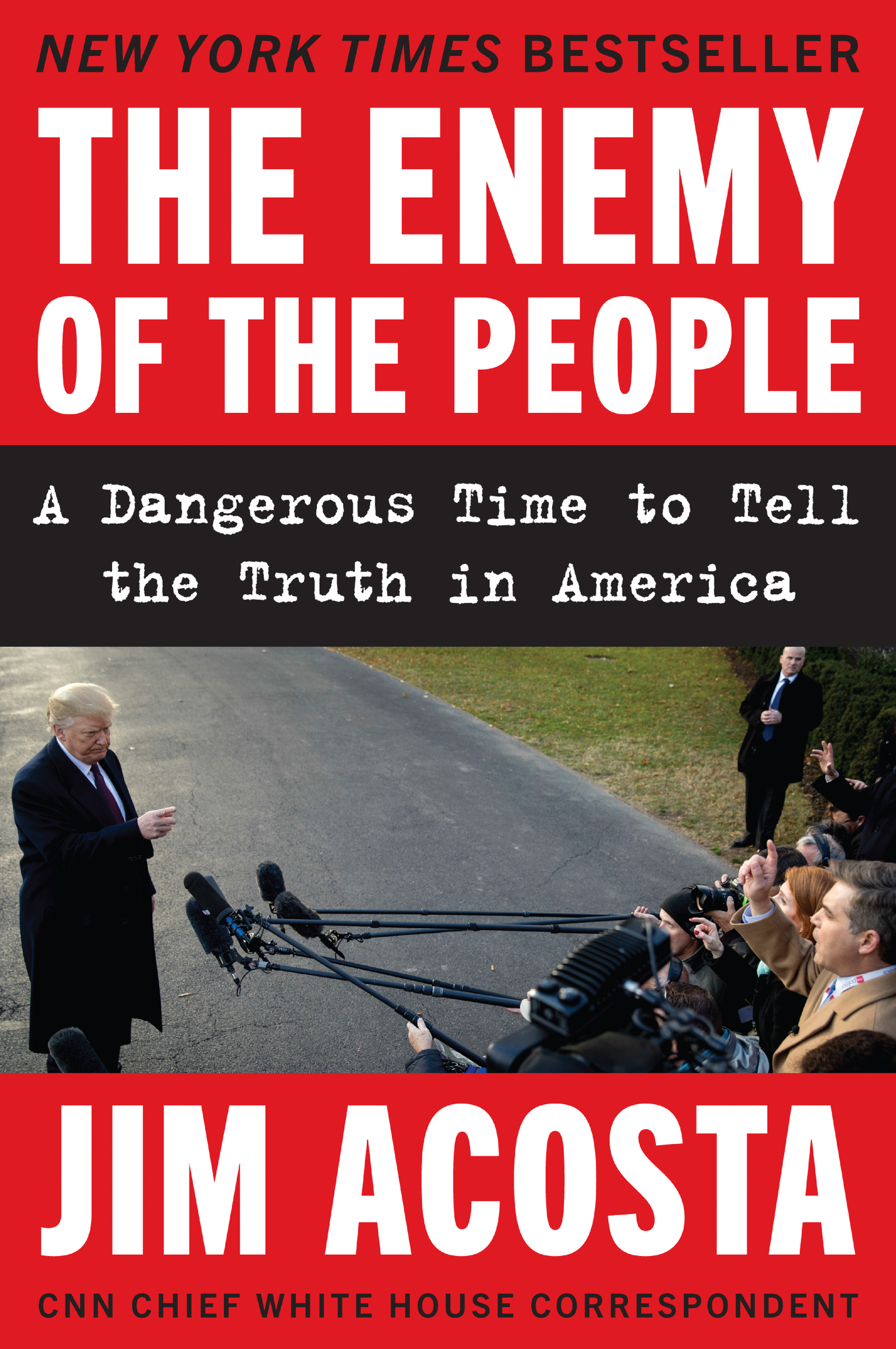
The Enemy of the People A New York Times bestseller. From CNN’s veteran Chief White House Correspondent Jim Acosta, an explosive, first-hand account of the dangers he faces reporting on the current White House while fighting on the front lines in President Trump’s war on truth, featuring new material exclusive to the paperback edition. In Mr. Trump’s campaign against what he calls “Fake News,†CNN Chief White House Correspondent, Jim Acosta, is public enemy number one. From the moment Mr. Trump announced his candidacy in 2015, he has attacked the media, calling journalists “the enemy of the people.†Acosta presents a damning examination of bureaucratic dysfunction, deception, and the unprecedented threat the rhetoric Mr. Trump is directing has on our democracy. When the leader of the free world incites hate and violence, Acosta doesn’t back down, and he urges his fellow citizens to do the same. At Mr. Trump’s most hated network, CNN, Acosta offers a never-before-reported account of what it’s like to be the President’s most hated correspondent. Acosta goes head-to-head with the White House, even after Trump supporters have threatened his life with words as well as physical violence. From the hazy denials and accusations meant to discredit the Mueller investigation, to the president’s scurrilous tweets, Jim Acosta is in the eye of the storm while reporting live to millions of people across the world. After spending hundreds of hours with the revolving door of White House personnel, Acosta paints portraits of the personalities of Sarah Huckabee Sanders, Stephen Miller, Steve Bannon, Sean Spicer, Hope Hicks, Jared Kushner and more. Acosta is tenacious and unyielding in his public battle to preserve the First Amendment and #RealNews. POLITICAL SCIENCE,Political Process,Campaigns & Elections
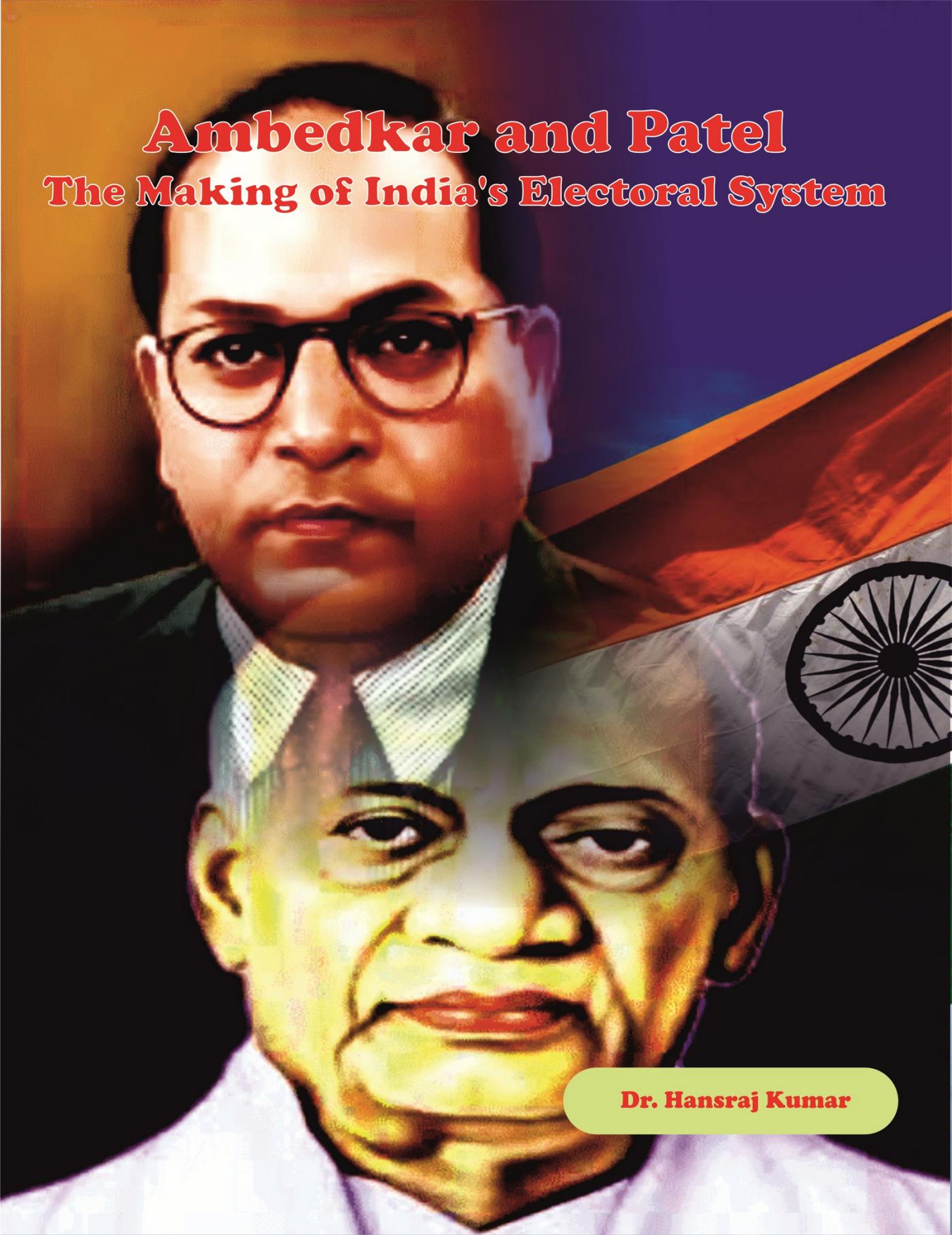
Ambedkar And Patel The Making Of India's Electoral System Bhimrao Ramji Ambedkar (14 April 1891 - 6 December 1956), also known as Ba-basaheb, was an Indian jurist, political leader, Buddhist activist, philosopher, thinker, anthropologist, historian, orator, prolific writer, economist, scholar, editor, revolutionary and a revivalist for Buddhism in India. He was also the chief architect of the Indian Constitution. Born into a poor Mahar, then Untouchable, family, Ambedkar spent his whole life fighting against social discrimination, the system of Chaturvarna - the categorization of Hindu society into four varnas - and the Hindu caste system. He is also credited with providing a spark for the conversion of hundreds of thousands of Dalits with his Ambedkar (ite) Buddhism. Ambedkar has been honoured with the Bharat Ratna, India's highest civilian award. Sardar Vallabhbhai Patel (31 October 1875-15 December 1950) was a political and social leader of India who played a major role in the country's struggle for independence and guided its integration into a united, independent nation. In India and across the world, he was often addressed as Sardar which means Chief in many languages of India. Vallabhbhai Patel, the 'Iron Man of India', was born in Nandiad, Gujarat, to Ladbai and Jhaverbhai Patel. He was one of their six children, five boys and a girl. There is no record of his date of birth. The generally accepted date, 31 October 1875, is taken from his matriculation certificate. It was an agriculturist family in which Vallabh was born and not a well-to-do one. His childhood was spent working on the family's ten acre farm at Karamsad, just like any other farmer's son, away from books. His education was thus erratic, though he was sent to the middle school at Karamsad from where he passed in his late teens POLITICAL SCIENCE,Political Process,Campaigns & Elections
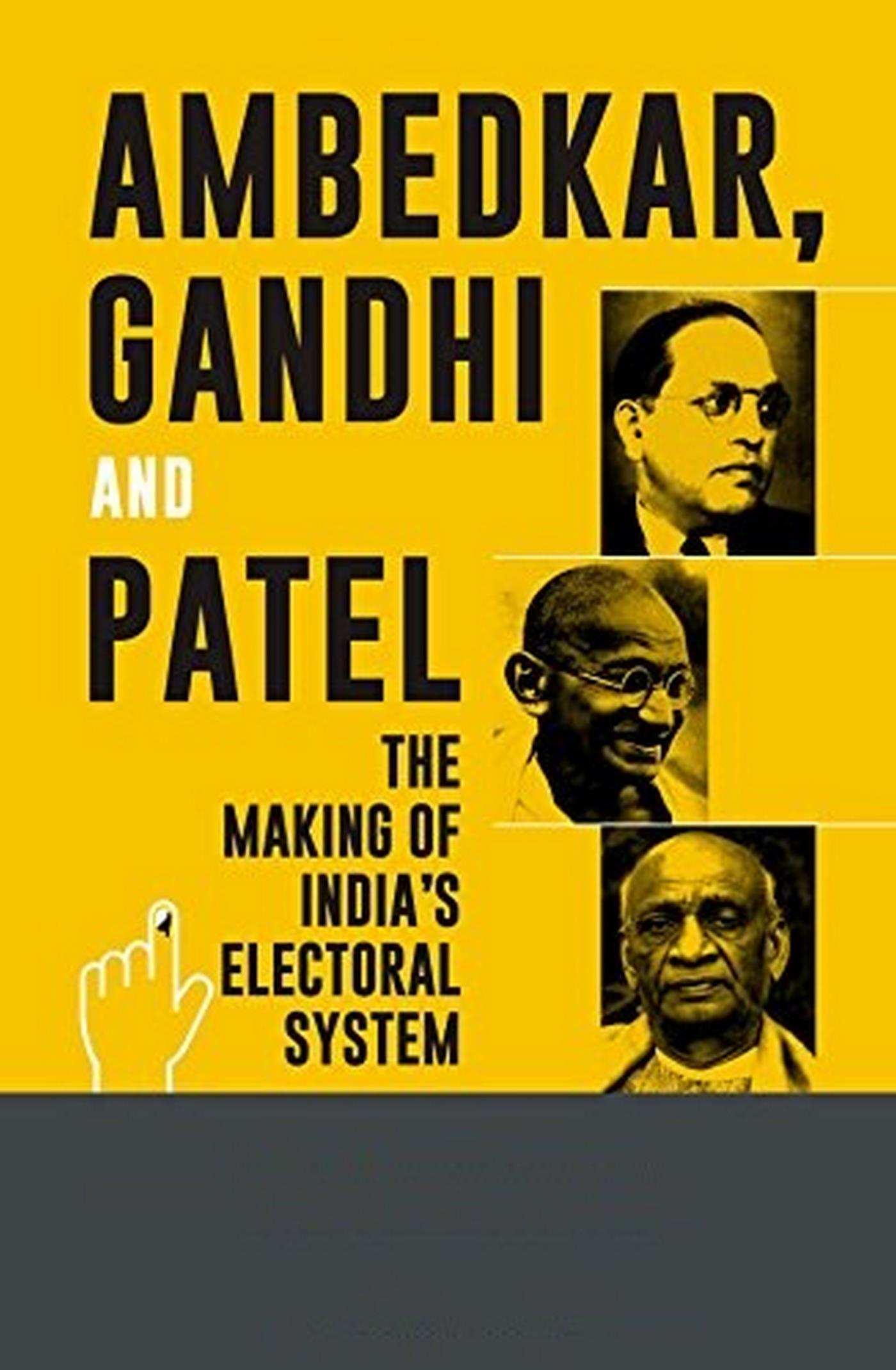
Ambedkar Gandhi And Patel The Making Of India's Electoral System Bhimrao Ramji Ambedkar (14 April 1891 - 6 December 1956), also known as Babasaheb, was an Indian jurist, political leader, Buddhist activist, philosopher, thinker, anthropologist, historian, orator, prolific writer, economist, scholar, editor, revolutionary and a revivalist for Buddhism in India. He was also the chief architect of the Indian Constitution. Born into a poor Mahar, then Untouchable, family, Ambedkar spent his whole life fighting against social discrimination, the system of Chaturvarna - the categorization of Hindu society into four varnas - and the Hindu caste system. He is also credited with providing a spark for the conversion of hundreds of thousands of Dalits with his Ambedkar (ite) Buddhism. Ambedkar has been honoured with the Bharat Ratna, India's highest civilian award. Gandhi was born on October 2, 1869, at Porbandar. Mohandas or Mohan was youngest of the three sons of Putlibai and Karamchand Gandhi. In January 1948, before three pistol shots put an end to his life, Gandhi had been on the political stage for more than fifty years. He had inspired two generations of India, patriots, shaken an empire and sparked off a revolution which was to change the face of Africa and Asia. To millions of his own people, he was the Mahatma-the great soul-whose sacred glimpse was a reward in itself. By the end of 1947 he had lived down much of the suspicion, ridicule and opposition which he had to face, when he first raised the banner of revolt against racial exclusiveness and imperial domination. His ideas, once dismissed as quaint and utopian, had begun to strike answering chords in some of the finest minds in the world. "Generations to come, it may be", Einstein had said of Gandhi in July 1944, "will scarcely believe that such one as this ever in flesh and blood walked upon earth." Sardar Vallabhbhai Patel (31 October 1875 - 15 December 1950) was a political and social leader of India who played a major role in the country's struggle for independence and guided its integration into a united, independent nation. In India and across the world, he was often addressed as Sardar which means Chief in many languages of India. Vallabhbhai Patel, the 'Iron Man of India', was born in Nandiad, Gujarat, to Ladbai and Jhaverbhai Patel. He was one of their six children, five boys and a girl. There is no record of his date of birth. The generally accepted date, 31 October 1875, is taken from his matriculation certificate. It was an agriculturist family in which Vallabh was born and not a well-to-do one. His childhood was spent working on the family's ten acre farm at Karamsad, just like any other farmer's son, away from books. His education was thus erratic, though he was sent to the middle school at Karamsad from where he passed in his late teens POLITICAL SCIENCE,Political Process,Campaigns & Elections

Rural Elections In China Unlike the election models in other Asian countries, rural elections in China were created from the grassroots level by farmers before they were officially and legally recognized by the government.As China is going through rapid urbanization and an increasing number of the rural population is moving to cities, village elections and power structures in the villages are also experiencing changes. By drawing on over 2,000 rural elections cases in China, this book analyzes the latest developments and deciphers their implications — not only for village elections, but also for China's democratization process. It also examines the interplay between state power and village elections: whether one grows at the expense of the other. Readers interested in China's rural elections will find this book a useful read. POLITICAL SCIENCE,Political Process,Campaigns & Elections

How Trump Stole 2020 Vote suppression is the key issue to the 2020 Election and Palast is the expert to explain why.... Has Trump already stolen the 2020 election? Vote theft was once considered to be a marginal issue that no one wanted to talk about, but as the stakes have risen and the facts have become known--in large part thanks to this author--it is now recognized as one of the central issues deciding our presidential elections. The scope is staggering. In the Georgia 2018 midterm election alone--the testing ground--Republican voting officials quietly removed half a million voters from the voter rolls--including Martin Luther King's ninety-two-year-old cousin Christine Jordan. How Trump Stole 2020 is the story of the racially poisonous schemes to steal the 2020 election, the political operatives behind the trickery--and the hard right billionaires funding it all, written by the investigative reporter who has been covering this story from the outset. POLITICAL SCIENCE,Political Process,Campaigns & Elections

The reimagined party Political parties are an established feature of contemporary democratic politics. For decades, parties have organised government, competed in elections and influenced the way society is run. Yet despite their importance, the status of political parties in society is presently unclear. On the one hand lambasted as duplicitous, self-interested, dogmatic organisations that are in decline, on the other they have been proclaimed as resurgent bodies that are attracting new levels of membership and support.The reimagined party offers unprecedented insight into public views of parties in Britain. Exploring public perceptions and desires, Katharine Dommett finds that far from rejecting parties, there is ongoing support for party democracy. The book presents evidence of a desire for change in party ethos, introducing the idea of the re-imagined party to explore perceptions of party representation, participation, governance and conduct. Using a mixed-method approach, and presenting hitherto unseen data, the book casts new light on citizen’s desires for parties today. POLITICAL SCIENCE,Political Process,Campaigns & Elections
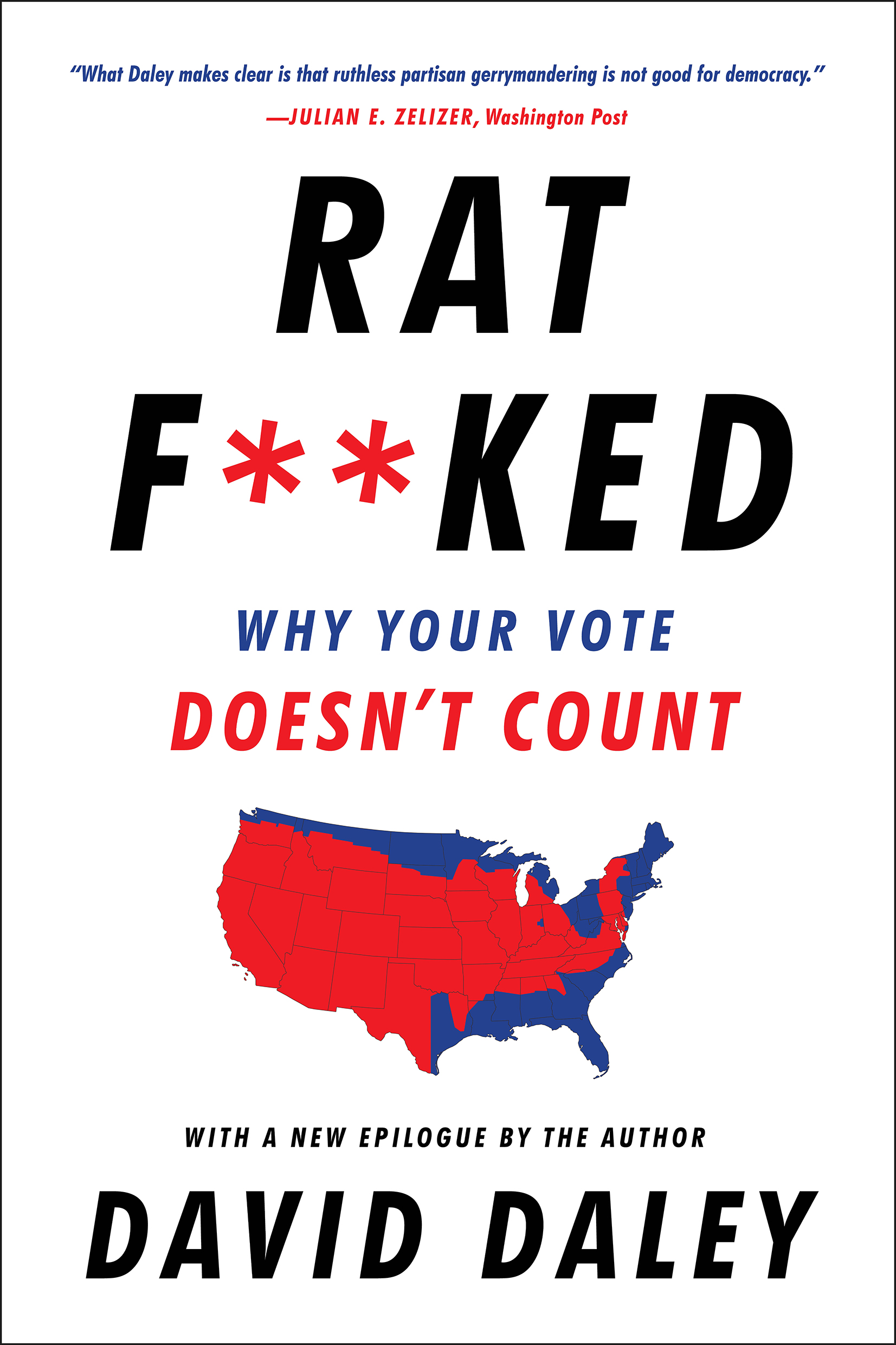
Ratf**ked David Daley’s “extraordinarily timely†(New York Times Book Review) account uncovers the fundamental rigging of our House of Representatives and state legislatures nationwide. Lauded as a “compelling†(The New Yorker) and “eye-opening tour of a process that many Americans never see†(Washington Post), David Daley’s Ratf**ked documents the effort of Republican legislators and political operatives to hack American democracy through an audacious redistricting plan called REDMAP. Since the revolutionary election of Barack Obama, a group of GOP strategists has devised a way to flood state races with a gold rush of dark money, made possible by Citizens United, in order to completely reshape Congress—and our democracy itself. “Sobering and convincing†(New York Review of Books), Ratf**ked shows how this program has radically altered America’s electoral map and created a firewall in the House, insulating the Republican party and its wealthy donors from popular democracy. While exhausted voters recover from a grueling presidential election, a new Afterword from the author explores the latest intense efforts by both parties, who are already preparing for the next redistricting cycle in 2020. POLITICAL SCIENCE,Political Process,Campaigns & Elections
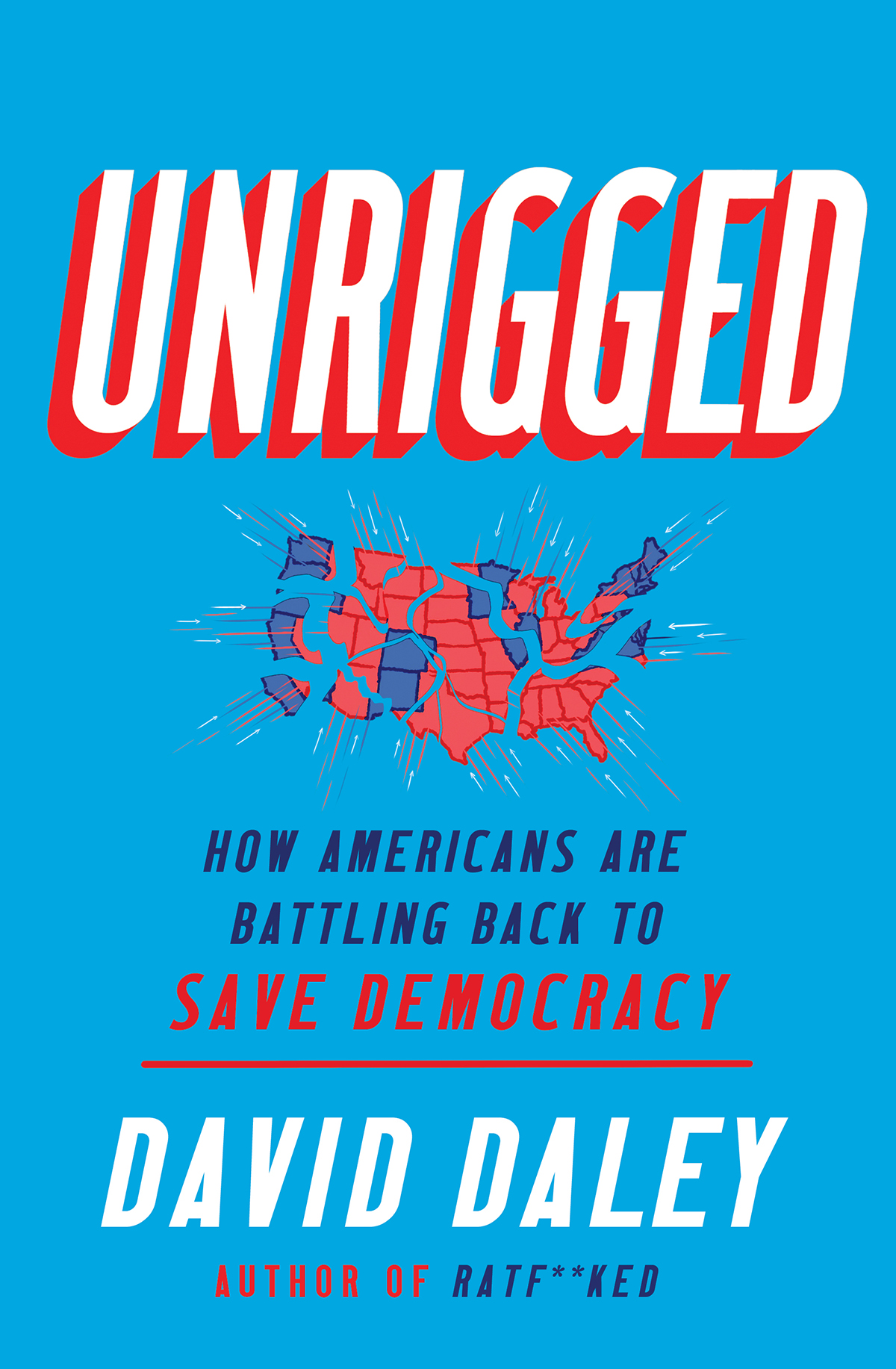
Unrigged A revelatory account by the best- selling author of Ratf**ked that will give you hope that America’s fragile democracy can still be saved. Following Ratf**ked, his “extraordinary timely and undeniably important†(New York Times Book Review) exposé of how a small cadre of Republican operatives rigged American elections, David Daley emerged as one of the nation’s leading authorities on gerrymandering. In Unrigged, he charts a vibrant political movement that is rising in the wake of his and other reporters’ revelations. With his trademark journalistic rigor and narrative flair, Daley reports on Pennsylvania’s dramatic defeat of a gerrymander using the research of ingenious mathematicians and the Michigan millennial who launched a statewide redistricting revolution with a Facebook post. He tells the stories of activist groups that paved the way for 2018’s historic blue wave and won crucial battles for voting rights in Florida, Maine, Utah, and nationwide. In an age of polarization, Unrigged offers a vivid portrait of a nation transformed by a new civic awakening, and provides a blueprint for what must be done to keep American democracy afloat. POLITICAL SCIENCE,Political Process,Campaigns & Elections

Turnout! Turnout! offers strategies for "emergency elections," like the 2020 races, and addresses the nuts-and-bolts for civic groups and individuals to effectively turn out the vote. Indeed, few elections in recent history represent the kind of apocalyptic turning point for our planet and democracy as the present one. Turnout! is both a creative work of political vision combined with a detailed manual for turning out millions of new voters. Participation at local, state, and federal levels will have an outsized impact on the future of democracy and life itself. The elections also provide an opportunity to power-up social movements that can re-frame and re-define civic participation in an age of extreme inequality, climate change, and pandemics. Contributors include powerful movement leaders Maria Teresa Kumar (Voto Latino), Aimee Allison (She the People), Winona LaDuke (Honor the Earth), and Matt Nelson (Presente.org); leading public officials advocating greater voter engagement like Oregon Senator Jeff Merkley and Wisconsin Lt. Governor Mandela Barnes, and councilors Helen Gym and Nikki Fortunato Bas. Turnout! reveals strategies and real-world tactics to mobilize millions of discouraged, apathetic, or suppressed voters, including women, low-income, Indigenous, Black, Latinx, Asian, LGBTQIA+, student and youth, and working-class voters. POLITICAL SCIENCE,Political Process,Campaigns & Elections

The Right to Be Elected What might happen if a woman's right to vote is seen as coequal with her right to be elected? Why are other countries so much better than the United States at electing women to office? In her lead essay in this anthology, Jennifer Piscopo argues that women in the United States haven't fought for the right to be elected. A comparative political scientist, she shows that suffrage movements around the world often focused not only on the right to vote, but also the right to stand for office. As a result, when these movements succeeded, they saw the right to be elected as a positive right, enabling nationwide-efforts to both encourage and actively recruit female candidates. In her exploration of positive and negative rights in the United States, Piscopo explores what might happen if a woman's right to vote is seen as coequal with her right to be elected, considering, among other things, how our definitions of representational government could both change and restore public trust in democracy. Other essays in this anthology similarly analyze history for lessons that can be applied to today's political climate. What effects does gender parity in legislatures have both on policies enacted and government performance? How has the complicated relationship between race and gender both informed and prevented progress for both movements? And, most immediately, what will it take for a woman to be elected as president in the United States? POLITICAL SCIENCE,Political Process,Campaigns & Elections

In So Many More Words When In So Many Words first appeared in 2006, the Chicago Tribune observed that Robert Schmuhl’s collection of essays offered “some of the sharpest and most informative cultural criticism available.†Now, In So Many More Words expands on the writings in the first edition and includes seventeen new essays written during the past four years. Schmuhl analyzes the emergence of Barack Obama and evaluates America’s new political landscape in light of the 2008 election. Schmuhl also looks at contemporary media and the cultural effects created by bloggers, pundits, and cable shouters. The explosive growth of news sources, he says, “comes at a public price—a continuing fragmentation of audiences and a marked decline in a commonly shared culture.†POLITICAL SCIENCE,Political Process,Campaigns & Elections

Power Shift in Germany Germany's landmark 1998 election saw for the first time in the Republic's fifty-year historyan incumbent Chancellor and his entire government replaced. In this collection fourteen distinguished scholars, from both sides of the Atlantic, have come together to give the first detailed scholarly account of this historic event. From a variety of perspectives the essays, based on in-depth interviews, explore the election candidates, parties, and issues, and places them within the context of the Federal Republic's history, the end of the Bonn Republic and the beginning of the Berlin Republic. Special chapters focus on the growing importance of women inelectoral politics, voting behavior and the influence of the media, and the significance of the election for the European Union. Based on in-depth interviews with political leaders and extensive field research this book is ideally suited for specialists in German and European politics and the interested reader who wants far more depth of coverage than the main stream media can provide. POLITICAL SCIENCE,Political Process,Campaigns & Elections

Eyewitness To Power From Nixon to Clinton, Watergate to Whitewater, few Americans have observed the ups and downs of presidential leadership more closely over the past thirty years than David Gergen. A White House adviser to four presidents, both Republican and Democrat, he offers a vivid, behind-the-scenes account of their struggles to exercise power and draws from them key lessons for leaders of the future. Gergen begins Eyewitness to Power with his reminiscence of being the thirty-year-old chief of the White House speechwriting team under Richard Nixon, a young man at the center of the Watergate storm. He analyzes what made Nixon strong -- and then brought him crashing down: Why Nixon was the best global strategist among recent presidents. How others may gain his strategic sense. How Nixon allowed his presidency to spin out of control. Why the demons within destroyed him. What lessons there are in Nixon's disaster. Gergen recounts how President Ford recruited him to help shore up his White House as special counsel. Here Gergen considers: Why Ford is one of our most underrated presidents. Why his pardon of Nixon was right on the merits but was so mishandled that it cost him his presidency. Even in his brief tenure, Ford offers lessons of leadership for others, as Gergen explains. Though Gergen had worked in two campaigns against him, Ronald Reagan called him back to the White House again, where he served as the Gipper's first director of communications. Here he describes: How Reagan succeeded where others have failed. Why his temperament was more important than his intelligence. How he mastered relations with Congress and the press. The secrets of "the Great Communicator" and why his speeches were the most effective since those of John Kennedy and Franklin Roosevelt. In 1993, Bill Clinton surprised Gergen -- and the political world -- when he recruited the veteran of Republican White Houses to join him as counselor after his early stumbles. Gergen reveals: Why Clinton could have been one of our best presidents but fell short. How the Bill-and-Hillary seesaw rocked the White House. How failures to understand the past brought Ken Starr to the door. Why the new ways in which leadership was developed by the Clinton White House hold out hope, and what dangers they threaten. As the twenty-first century opens, Gergen argues, a new golden age may be dawning in America, but its realization will depend heavily upon the success of a new generation at the top. Drawing upon all his many experiences in the White House, he offers seven key lessons for leaders of the future. What they must have, he says, are: inner mastery; a central, compelling purpose rooted in moral values; a capacity to persuade; skills in working within the system; a fast start; a strong, effective team; and a passion that inspires others to keep the flame alive. Eyewitness to Power is a down-to-earth, authoritative guide to leadership in the tradition of Richard Neustadt's Presidential Power and the Modern Presidents. POLITICAL SCIENCE,Political Process,General
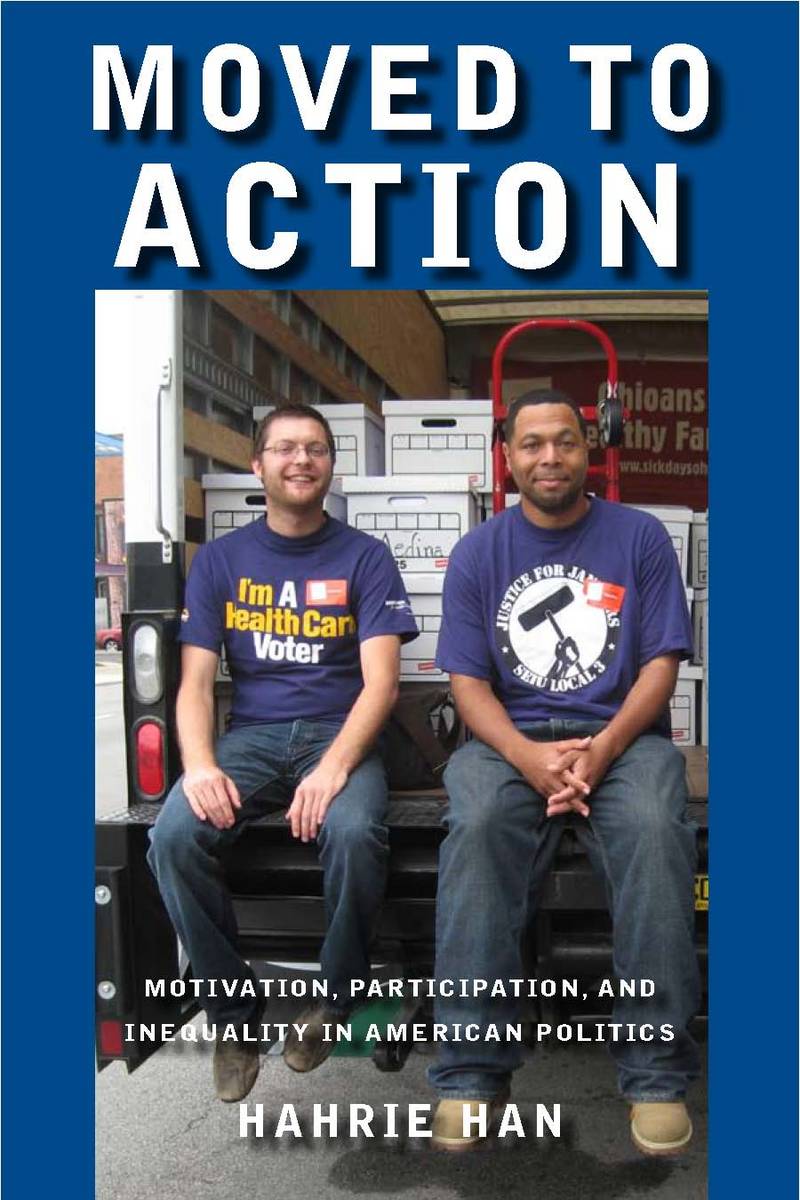
Moved to Action The book examines how the underprivileged become motivated to participate in politics even though they lack the educational, financial, and civic resources commonly assumed to be necessary for participation. POLITICAL SCIENCE,Political Process,General
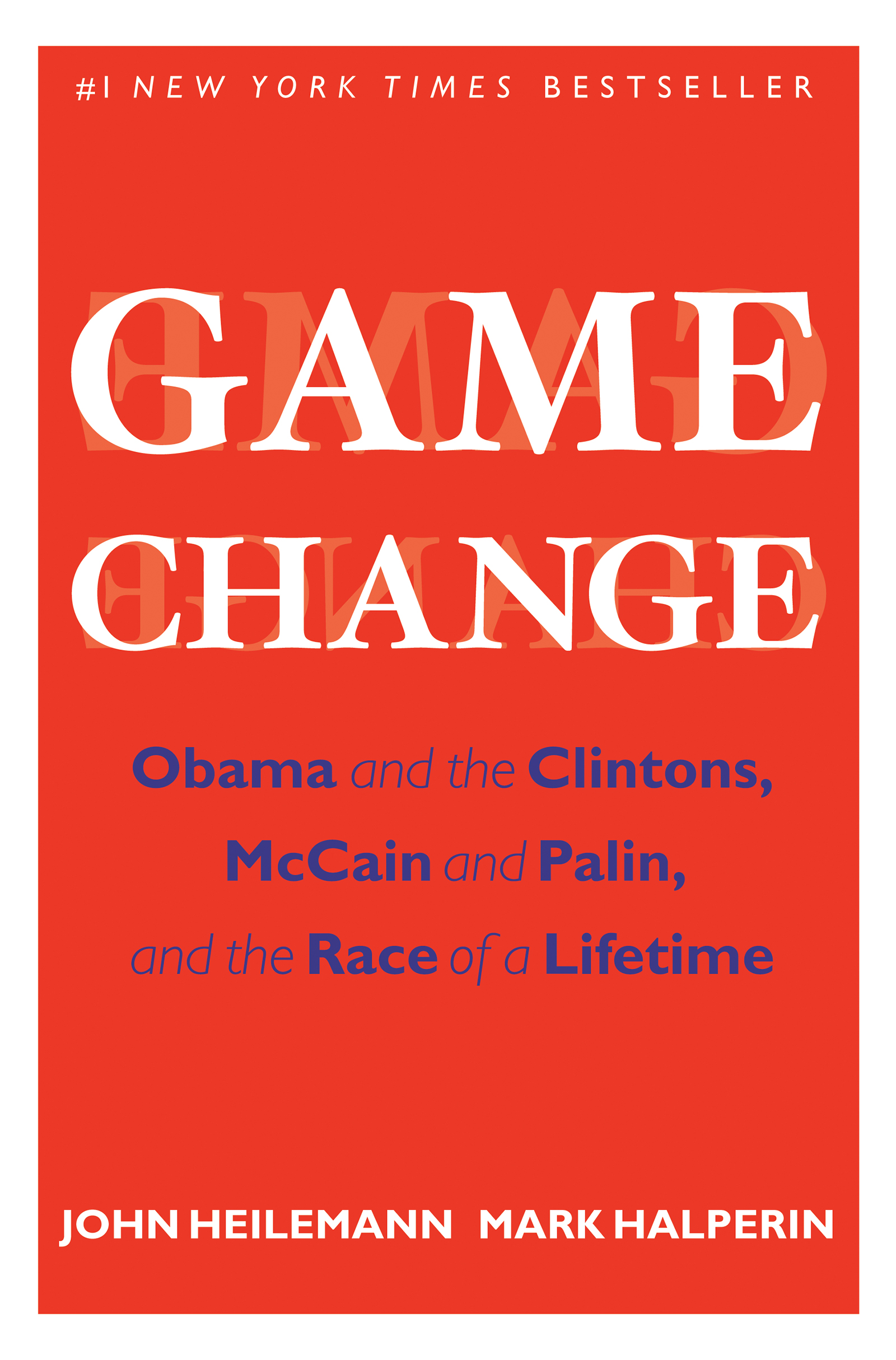
Game Change The gripping inside story of the 2008 presidential election, by two of the best political reporters in the country. “It’s one of the best books on politics of any kind I’ve read. For entertainment value, I put it up there with Catch 22.†—The Financial Times “It transports you to a parallel universe in which everything in the National Enquirer is true….More interesting is what we learn about the candidates themselves: their frailties, egos and almost super-human stamina.†—The Financial Times “I can’t put down this book!†—Stephen Colbert Game Change is the New York Times bestselling story of the 2008 presidential election, by John Heilemann and Mark Halperin, two of the best political reporters in the country. In the spirit of Richard Ben Cramer’s What It Takes and Theodore H. White’s The Making of the President 1960, this classic campaign trail book tells the defining story of a new era in American politics, going deeper behind the scenes of the Obama/Biden and McCain/Palin campaigns than any other account of the historic 2008 election. POLITICAL SCIENCE,Political Process,General

The New Prince Niccolo Machiavelli's The Prince has been one of the most widely read and quoted book about politics during the past five centuries. But in the democracies of the information age, new ideas are needed to make government prosper through the next century. Now, Dick Morris, who contributed significantly to President Clinton's reelection in 1996 and, during the previous two decades, helped many public officials (Democrats and Republicans alike) gain office, takes a hard look at our times and writes a how-to book for office-seekers, special-interest groups, and students of politics. In The New Prince, Morris advises candidates to adopt idealism as a strategy—not because of misguided altruism, but because it works. He tells politicians, advocacy groups, business leaders, and citizens how to promote their causes and get their jobs done effectively. And he offers insights into the character of the most remarkable political figures of our time and outlines what he believes will be the political agenda for the next century. POLITICAL SCIENCE,Political Process,General

Fear and Loathing on the Campaign Trail '72 From the legendary journalist and creator of “Gonzo†journalism Hunter S. Thompson comes the bestselling critical look at Nixon and McGovern’s 1972 presidential election. Forty years after its original publication, Fear and Loathing on the Campaign Trail ’72 remains a cornerstone of American political journalism and one of the bestselling campaign books of all time. Hunter S. Thompson’s searing account of the battle for the 1972 presidency—from the Democratic primaries to the eventual showdown between George McGovern and Richard Nixon—is infused with the characteristic wit, intensity, and emotional engagement that made Thompson “the flamboyant apostle and avatar of gonzo journalism†(The New York Times). Hilarious, terrifying, insightful, and compulsively readable, Fear and Loathing on the Campaign Trail ’72 is an epic political adventure that captures the feel of the American democratic process better than any other book ever written. POLITICAL SCIENCE,Political Process,General
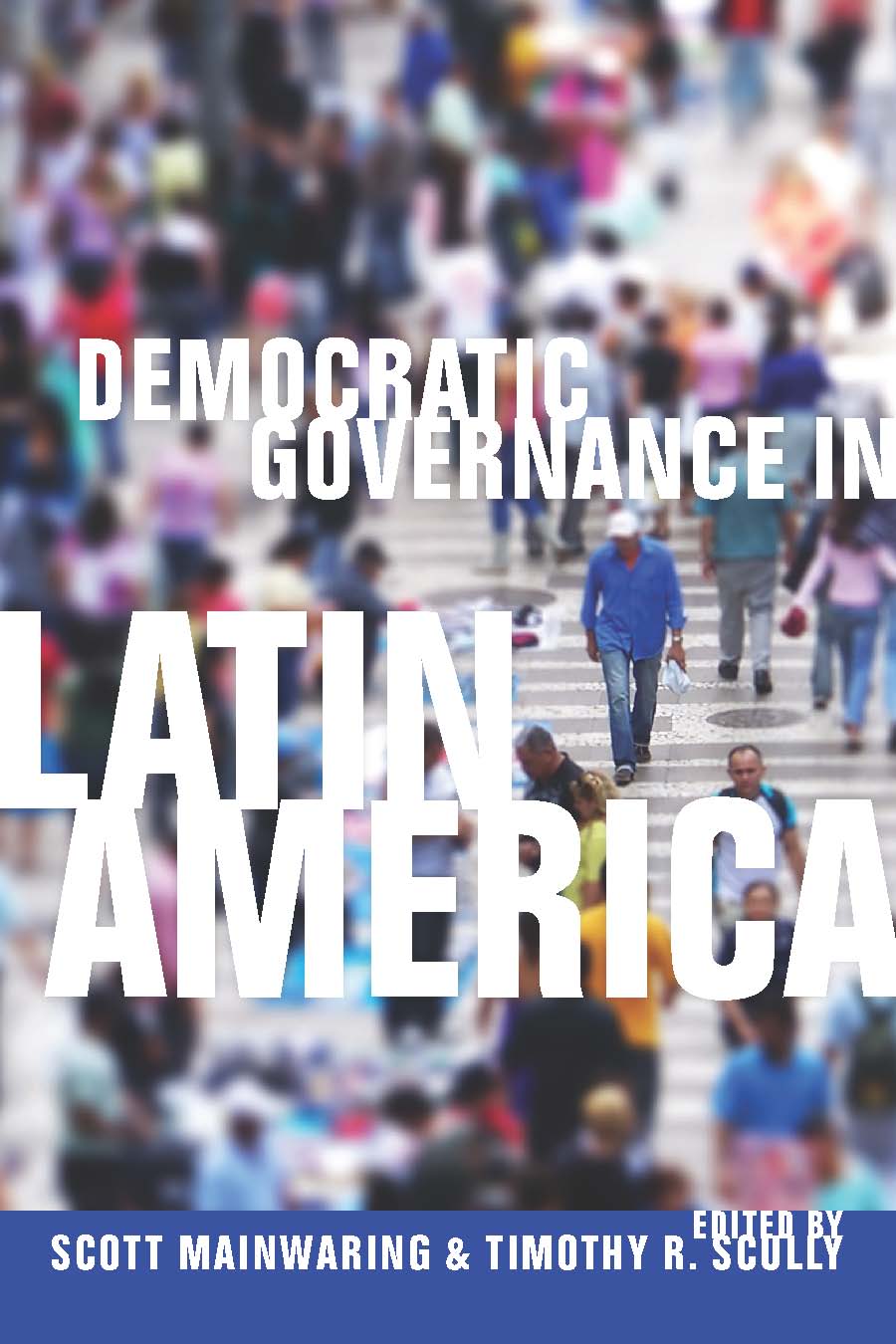
Democratic Governance in Latin America Producing more effective governance is the greatest challenge that faces most Latin American democracies today—a challenge that involves not only strengthening democratic institutions but also increasing governmental effectiveness. Focusing on the post-1990 period, this volume addresses why some policies and some countries have been more successful than others in meeting this dual challenge. Two features of the volume stand out. First, whereas some analysts tend to generalize for Latin America as a whole, this group of authors underscores the striking differences of achievement among countries in the region and illustrates the importance of understanding these differences. The second feature is the range of expertise within the volume. In addition to the volume editors, the contributors are Alan Angell, Daniel Brinks, Fernando Henrique Cardoso, José de Gregorio, Alejandro Foxley, Evelyne Huber, José Miguel Insulza, Juliana MartÃnez Franzoni, Patricio Navia, Francisco Rodriguez, Mitchell Seligson, John Stephens, Jorge Vargas Cullell, and Ignacio Walker. POLITICAL SCIENCE,Political Process,General
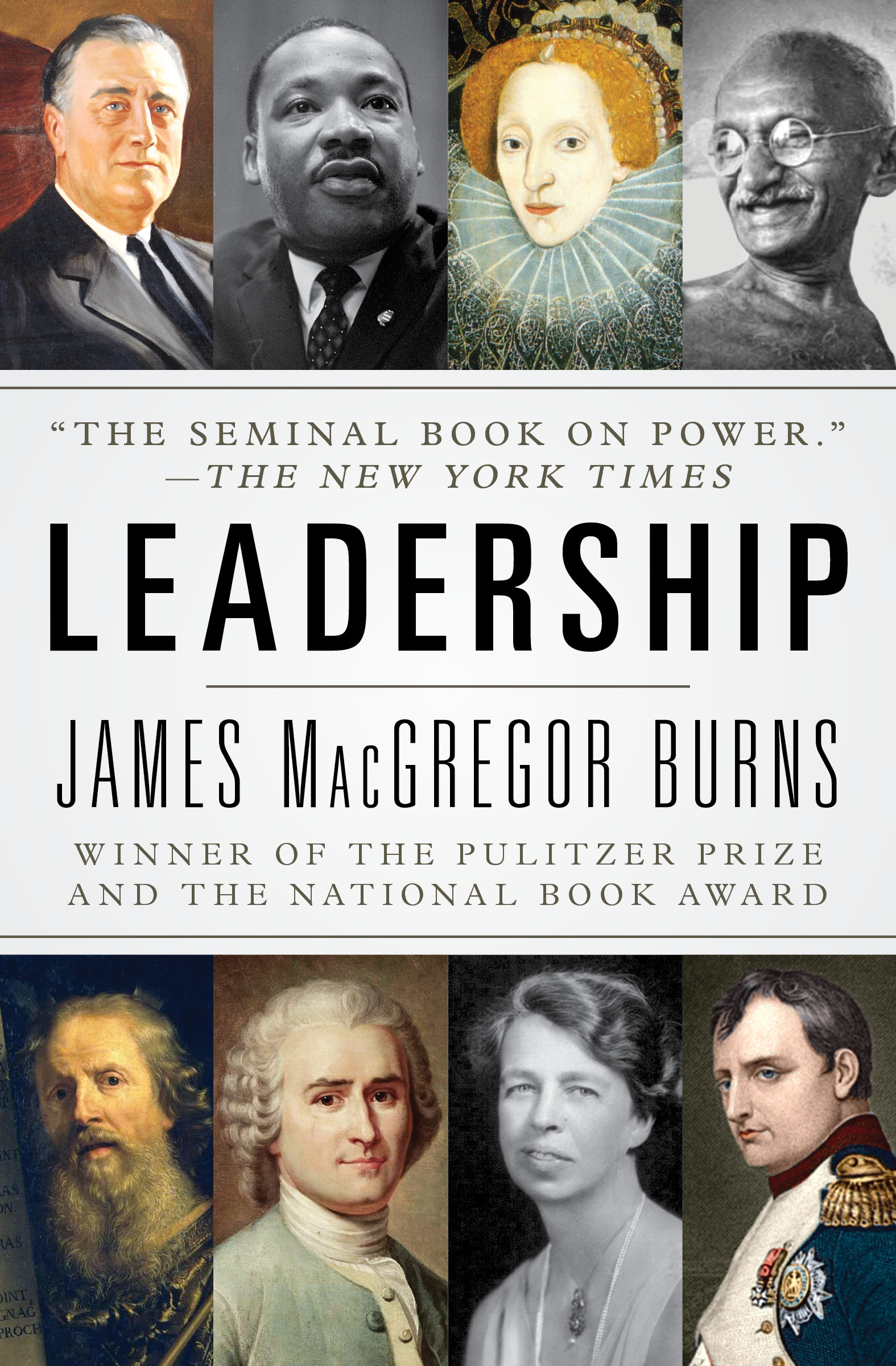
Leadership A Pulitzer Prize–winning historian examines transformational leaders from Moses to Machiavelli to Martin Luther King Jr. in this “impressive book†(The Washington Post). Historian and political scientist James MacGregor Burns has spent much of his career documenting the use and misuse of power by leaders throughout history. In this groundbreaking study, Burns examines the qualities that make certain leaders—in America and elsewhere—succeed as transformative figures. Through insightful anecdotes and historical analysis, Burns scrutinizes the charisma, vision, and persuasive power of individuals able to imbue followers with a common sense of purpose, from the founding fathers to FDR, Gandhi to Napoleon. Since its original publication in 1970, Leadership has set the standard for scholarship in the field. POLITICAL SCIENCE,Political Process,General
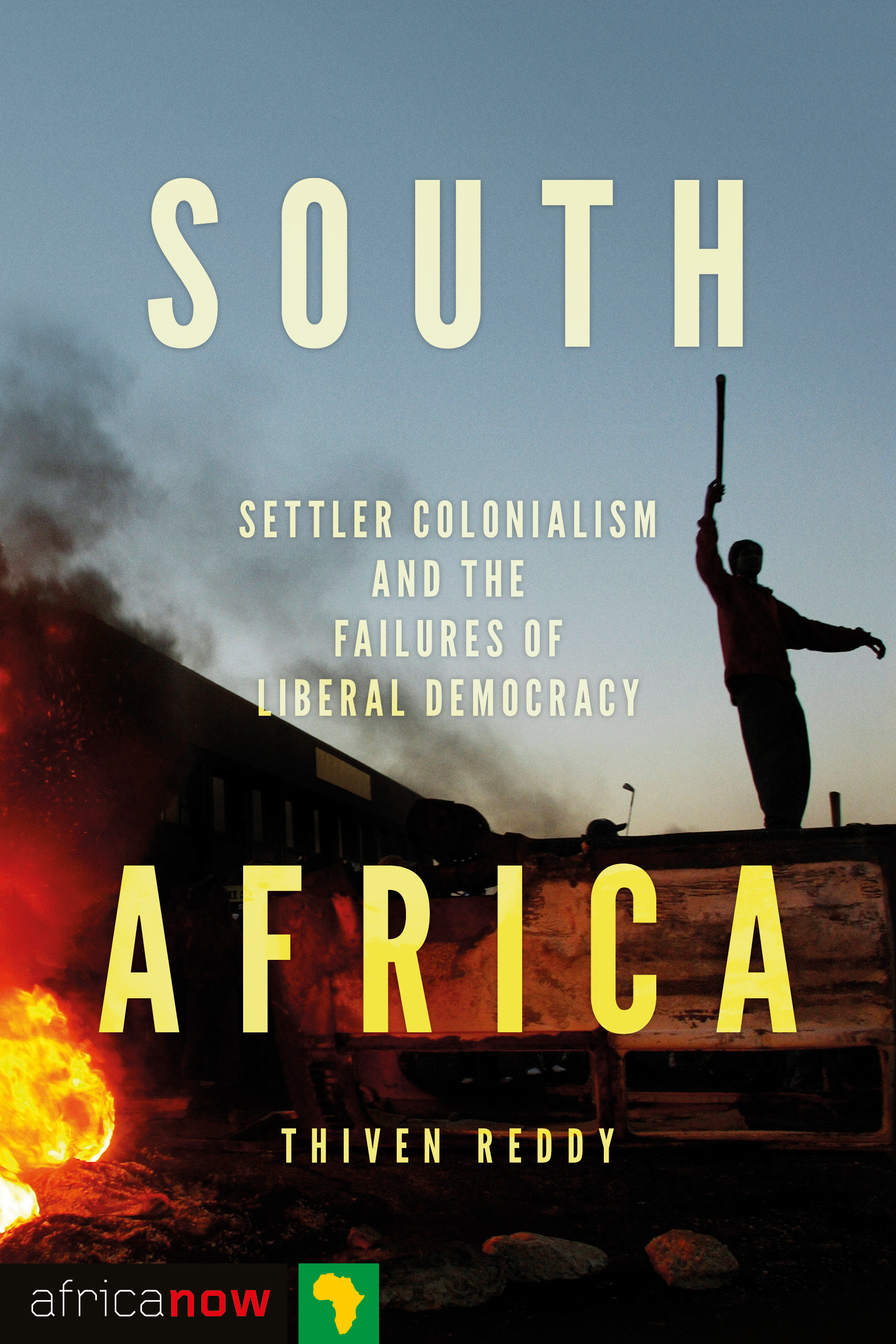
South Africa, Settler Colonialism and the Failures of Liberal Democracy A vital and original interrogation of the contradictions and tensions of liberal democracy in post-Apartheid South Africa. POLITICAL SCIENCE,Political Process,General
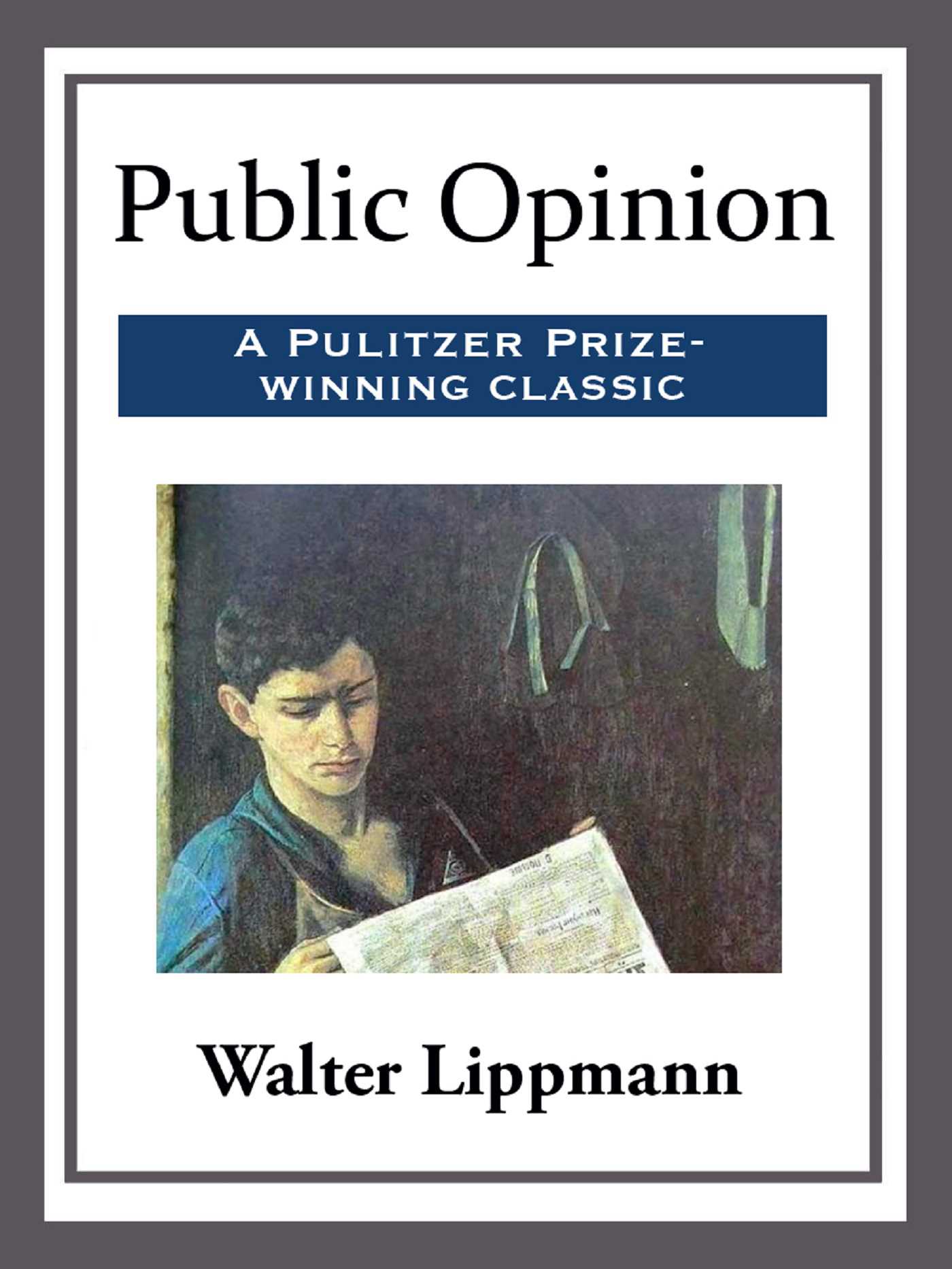
Public Opinion Public Opinion exposes how media can shape public perception and how that perception changes society. Walter Lippmann is a two-time Pulitzer Prize-winner and visionary. POLITICAL SCIENCE,Political Process,General
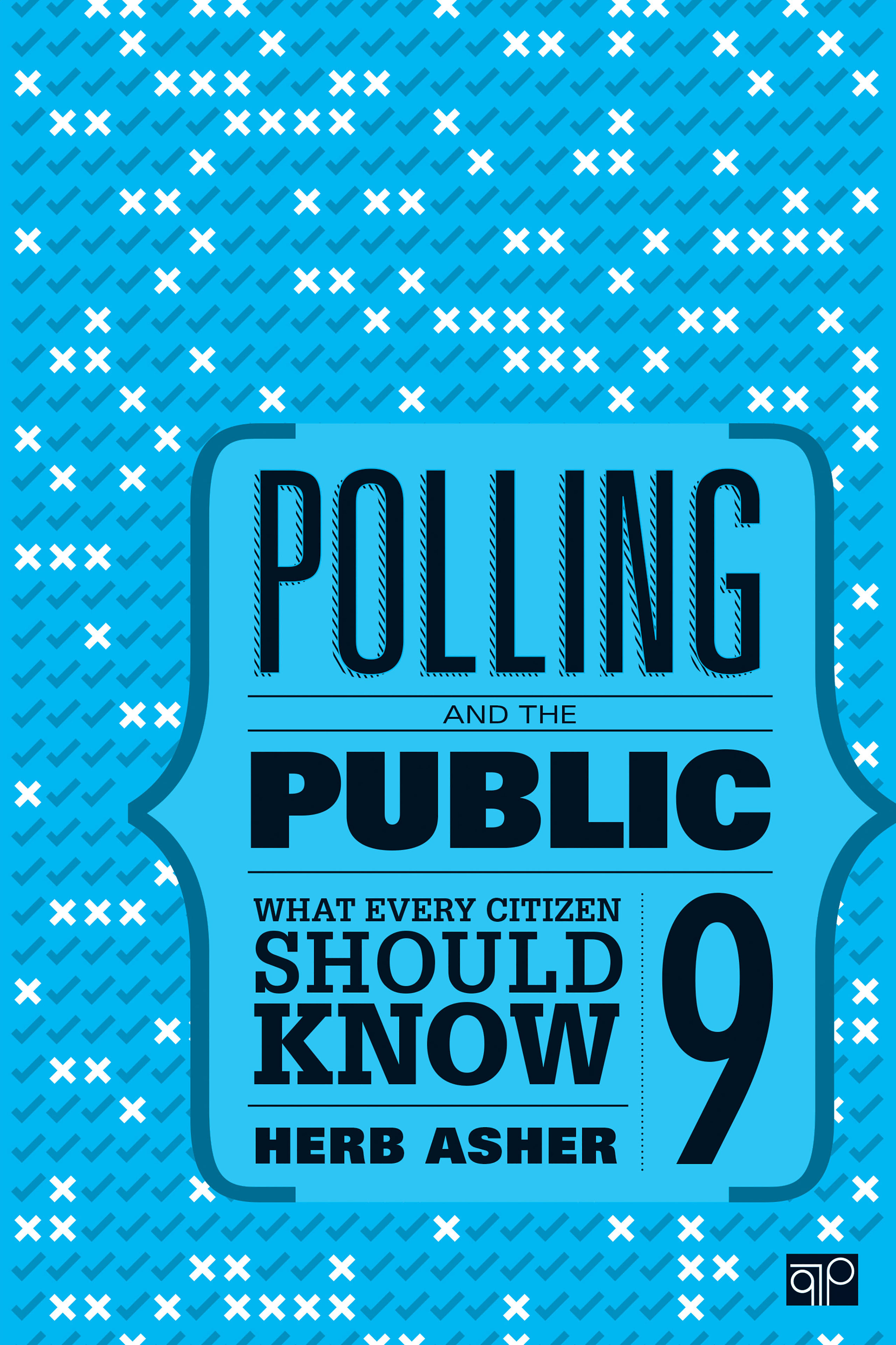
Polling and the Public Polling and the Public helps readers become savvy consumers of public opinion polls, offering solid grounding on how the media cover them, their use in campaigns and elections, and their interpretation. This trusted, brief guide by Herb Asher also provides a non-technical explanation of the methodology of polling so that students become informed participants in political discourse. Fully updated with new data and scholarship, the Ninth Edition examines recent elections and the use and misuse of polls in campaigns, and delivers new coverage of web-based and smartphone polling. POLITICAL SCIENCE,Political Process,General
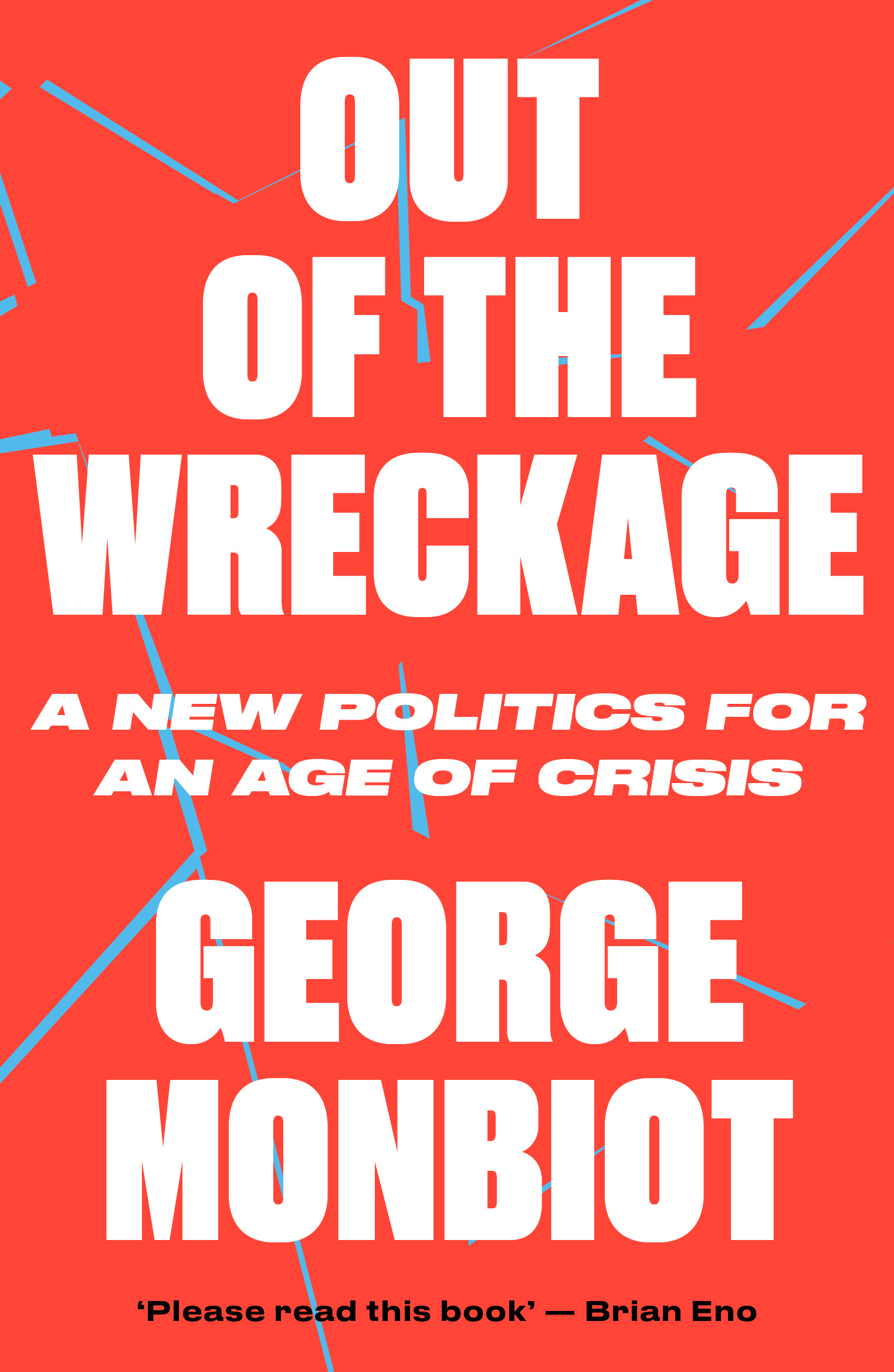
Out of the Wreckage A thrilling new route to a better society A toxic ideology of extreme competition and individualism has come to dominate our world. It misrepresents human nature, destroying hope and common purpose. Only a positive vision can replace it, a new story that re-engages people in politics and lights a path to a better future. George Monbiot shows how new findings in psychology, neuroscience and evolutionary biology cast human nature in a radically different light: as the supreme altruists and cooperators. He shows how we can build on these findings to create a new politics: a “politics of belonging.” Both democracy and economic life can be radically reorganized from the bottom up, enabling us to take back control and overthrow the forces that have thwarted our ambitions for a better society. Urgent and passionate, Out of the Wreckage provides the hope and clarity required to change the world. POLITICAL SCIENCE,Political Process,General

Barack Obama in his Own Words Since delivering his keynote speech at the 2004 Democratic National Convention, Barack Obama has been hailed as the clear savior of not only the Democratic party, but of the integrity of American politics. Despite the fact that he burst onto the national scene seemingly overnight, his name recognition has grown by leaps and bounds ever since. Barack Obama in His Own Words, a book of quotes from the Illinois Senator, allows those who aren't as familiar with his politics to learn quickly where he stands on abortion, religion, AIDS, his critics, foreign policy, Iraq, the War on Terror, unemployment, gay marriage, and a host of other important issues facing America and the world. POLITICAL SCIENCE,Political Process,General

Forged in Crisis A WALL STREET JOURNAL BESTSELLER “Five gritty leaders whose extraordinary passion and perseverance changed history…a gripping read on a timeless and timely topic†—Angela Duckworth, #1 bestselling author of Grit An enthralling historical narrative filled with critical leadership insights, Forged in Crisis, by celebrated Harvard Business School historian Nancy Koehn, spotlights five masters of crisis: polar explorer Ernest Shackleton; President Abraham Lincoln; legendary abolitionist Frederick Douglass; Nazi-resisting clergyman Dietrich Bonhoeffer; and environmental crusader Rachel Carson. What do such disparate figures have in common? Why do their extraordinary stories continue to amaze and inspire? In delivering the answers to those questions, Nancy Koehn offers a remarkable template by which to judge those in our own time to whom the public has given its trust. She begins each of the book’s five sections by showing her protagonist on the precipice of a great crisis: Shackleton marooned on an Antarctic ice floe; Lincoln on the verge of seeing the Union collapse; escaped slave Douglass facing possible capture; Bonhoeffer agonizing over how to counter absolute evil with faith; Carson racing against the cancer ravaging her in a bid to save the planet. The narrative then reaches back to each person’s childhood and shows the individual growing—step by step—into the person he or she will ultimately become. Significantly, as we follow each leader’s against-all-odds journey, we begin to glean an essential truth: leaders are not born but made. In a book dense with epiphanies, the most galvanizing one may be that the power to lead courageously resides in each of us. Whether it’s read as a repository of great insight or as exceptionally rendered human drama, Forged in Crisis stands as a towering achievement. POLITICAL SCIENCE,Political Process,General
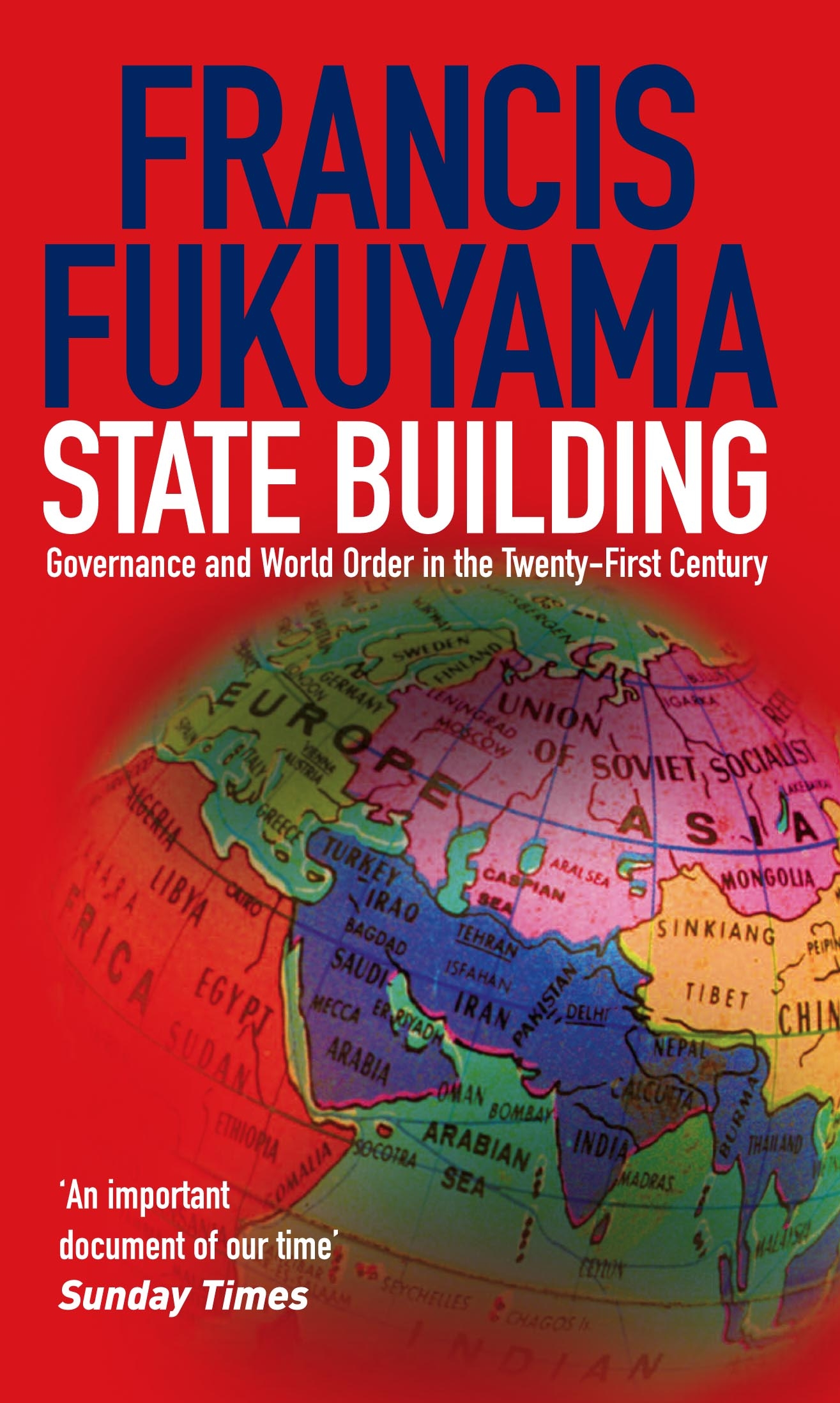
State Building Weak or failed states - where no government is in control - are the source of many of the world's most serious problems, from poverty, AIDS and drugs to terrorism. What can be done to help? The problem of weak states and the need for state-building has existed for many years, but it has been urgent since September 11 and Afghanistan and Iraq. The formation of proper public institutions, such as an honest police force, uncorrupted courts, functioning schools and medical services and a strong civil service, is fraught with difficulties. We know how to help with resources, people and technology across borders, but state building requires methods that are not easily transported. The ability to create healthy states from nothing has suddenly risen to the top of the world agenda. State building has become a crucial matter of global security. In this hugely important book, Francis Fukuyama explains the concept of state-building and discusses the problems and causes of state weakness and its national and international effects. POLITICAL SCIENCE,Political Process,General
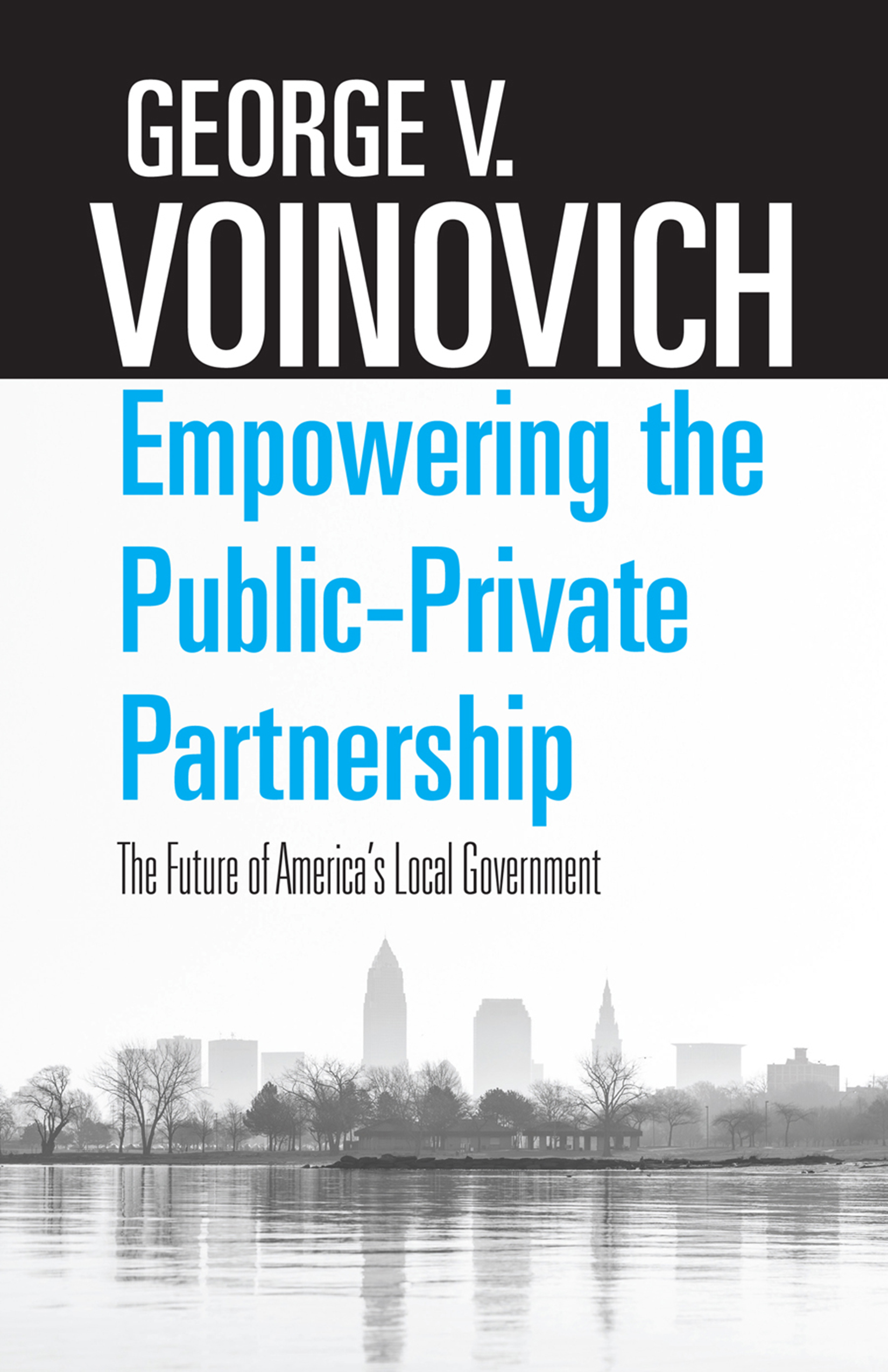
Empowering the Public-Private Partnership Using lessons from Cleveland, Mayor George V. Voinovich developed this handbook for governments and private entities seeking a mutually enriching partnership. It is his legacy to those who will guide America’s cities to new growth and vitality. POLITICAL SCIENCE,Political Process,General

Launching the Grand Coalition This edited volume, which brings together the leading experts in German politics from around the US and Germany, combines rich descriptive data with insightful analyses regarding one of the most dramatic and important election years in postwar Germany. A variety of more specialized issues and perspectives is addressed, including the transatlantic relationship, EU policy, voting behavior and far Right parties. This book will be essential reading for students of German, European and comparative politics. POLITICAL SCIENCE,Political Process,General
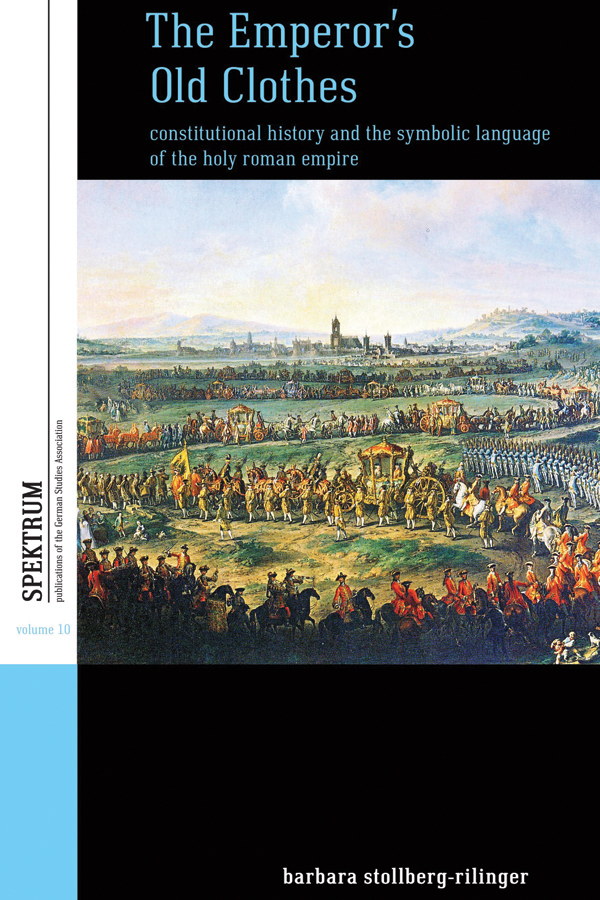
The Emperor's Old Clothes For many years, scholars struggled to write the history of the constitution and political structure of the Holy Roman Empire. This book argues that this was because the political and social order could not be understood without considering the rituals and symbols that held the Empire together. What determined the rules (and whether they were followed) depended on complex symbolic-ritual actions. By examining key moments in the political history of the Empire, the author shows that it was a vocabulary of symbols, not the actual written laws, that formed a political language indispensable in maintaining the common order. POLITICAL SCIENCE,Political Process,General
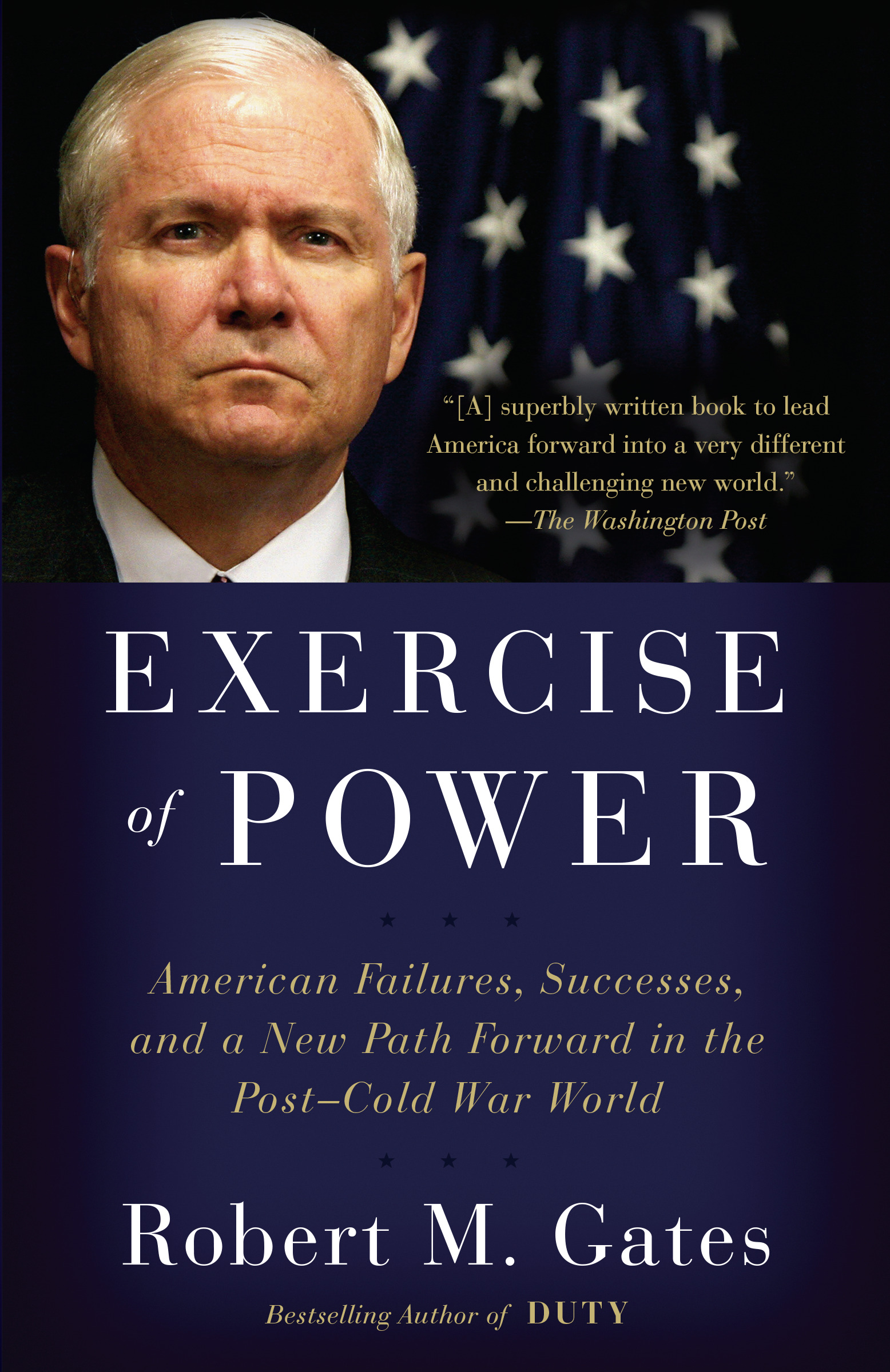
Exercise of Power From the former secretary of defense and author of the acclaimed #1 best-selling memoir, Duty, a candid, sweeping examination of power in all its manifestations, and how it has been exercised, for good and bad, by American presidents in the post-Cold War world. Since the end of the Cold War, the global perception of the United States has progressively morphed from dominant international leader to disorganized entity, seemingly unwilling to accept the mantle of leadership or unable to govern itself effectively. Robert Gates argues that this transformation is the result of the failure of political leaders to understand the complexity of American power, its expansiveness, and its limitations. He makes clear that the successful exercise of power is not limited to the use of military might or the ability to coerce or demand submission, but must encompass as well diplomacy, economics, strategic communications, development assistance, intelligence, technology, ideology, and cyber. By analyzing specific challenges faced by the American government in the post-Cold War period--Iran, Iraq, Afghanistan, North Korea, Syria, Libya, Russia, China, and others--Gates deconstructs the ways in which leaders have used the instruments of power available to them. With forthright judgments of the performance of past presidents and their senior-most advisers, firsthand knowledge, and insider stories, Gates argues that U.S. national security in the future will require learning, and abiding by, the lessons of the past, and re-creating those capabilities that the misuse of power has cost the nation. POLITICAL SCIENCE,Political Process,General
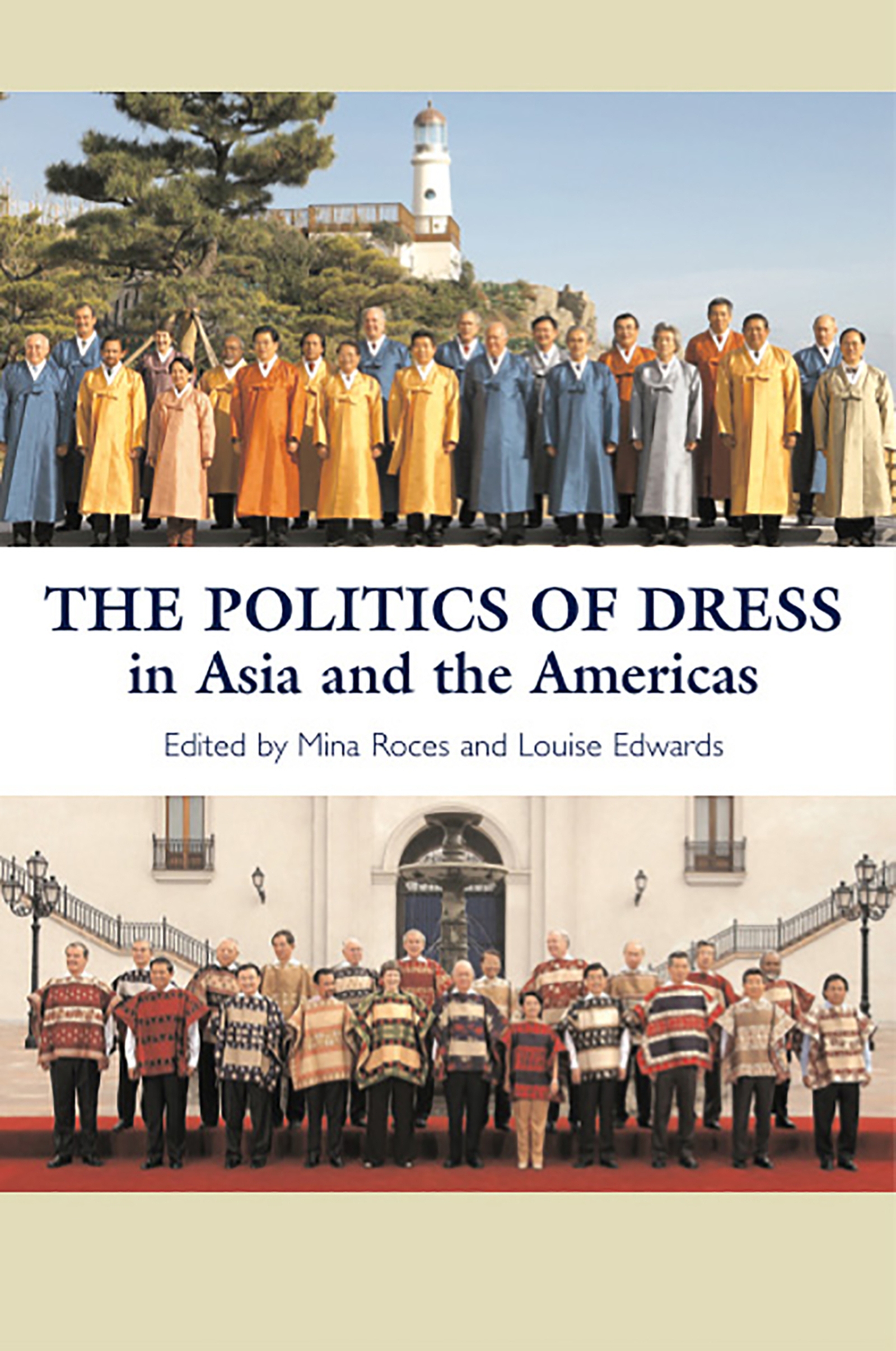
The Politics of Dress in Asia and the Americas This book explores the ways in which dress has been influential in the political agendas and self-representations of politicians in a variety of regimes, from democratic to authoritarian. Arguing that dress is part of 'hard core' politics, the book - now in paperback - shows how dress has been crucial to the constructions of nationhood and national identities in both Asia and the Americas. Since dress has been a marker of identity and status, chapters engage with the gendering of the politics of dress, discussing how women have become bearers and wearers of 'national tradition' and how men's and women's dress reflect their political positions in the nation-state. It examines the magical power of cloth, the meanings of batik and design, the holy status of uncut cloth vs. cut cloth, and the quaint combination of non-Western with Western attire. This collection of pioneering essays fills a vacuum in the largely Eurocentric field of dress studies, demanding that attention be paid to Asia and the Americas as major sites of vestimentary creativity. POLITICAL SCIENCE,Political Process,General

Religion and Politics in Jammu and Kashmir This book examines the shifting, non-linear relationship between religion, nationalism and politics in the state of Jammu and Kashmir, India. In the wake of the revocation of Article 370, the state’s plural and relatively harmonious society has come under multiple strains, with religion often informing day-to-day politics. The chapters in this volume: Trace the formation of the political entity of Jammu and Kashmir and the seemingly secular politics of its three regions Discuss the rise of militancy and resistance movements in the Kashmir Valley Highlight the intersection between everyday life, nationalism and resistance through a study of the literary traditions of Kashmir, contemporary resistance photography and everyday communalism located in the changing food practices of Hindu and Muslim communities Religion and Politics in Jammu and Kashmir will be an indispensable read for students and researchers of religion and politics, democratization and democracy, secularism, sociology, cultural studies and South Asian studies. POLITICAL SCIENCE,Political Process,General
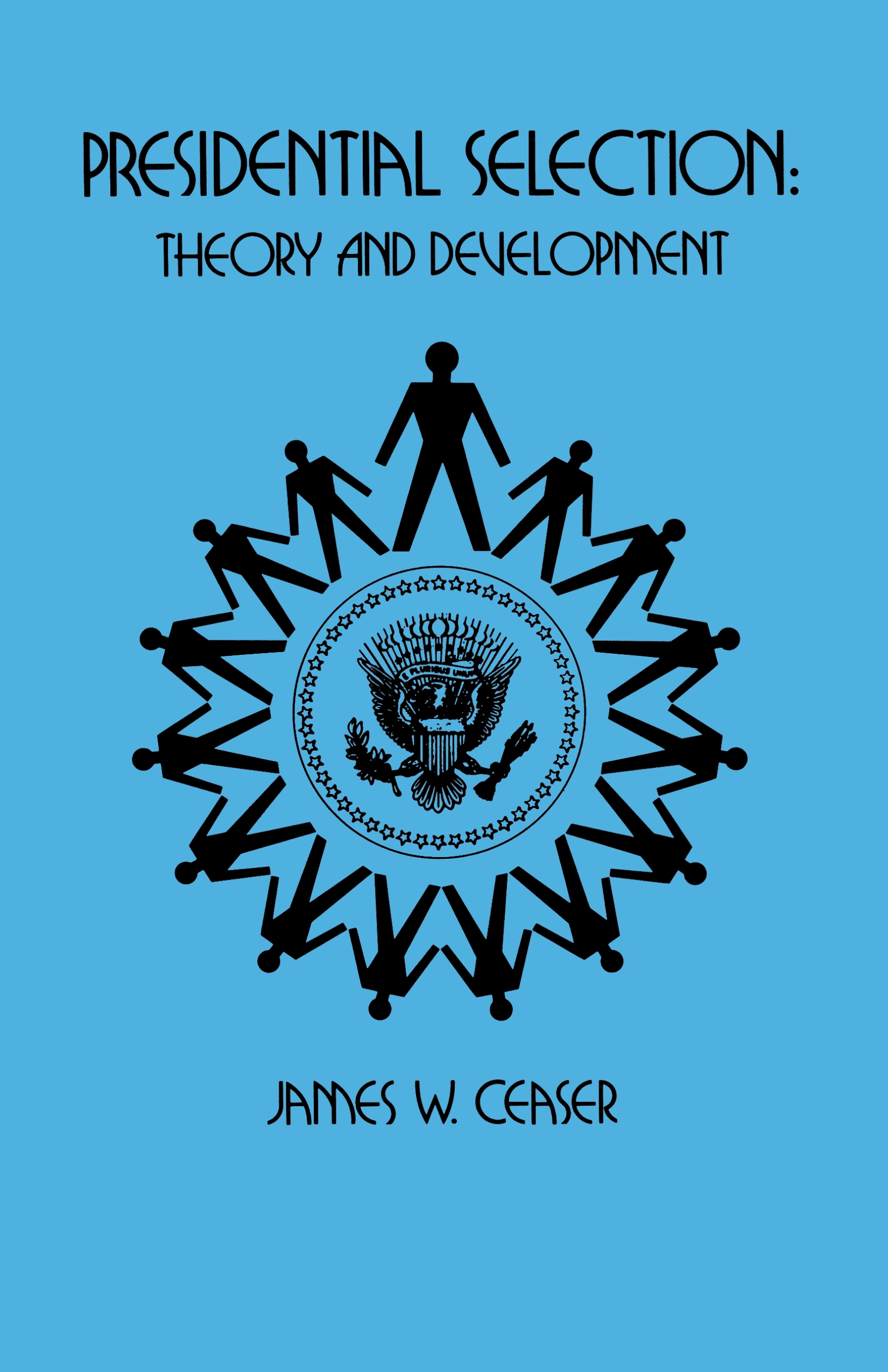
Presidential Selection Examining the development of the process of presidential selection from the founding of the republic to the present day, James Ceaser contends that many of the major purposes of the selection system as it was formerly understood have been ignored by current reformers and modern scholars. In an attempt to reverse this trend, Professor Ceaser discusses the theories of selection offered by leading American statesmen from the Founders and Thomas Jefferson to Martin Van Buren and Woodrow Wilson. From these theories he identifies a set of criteria for a sound selection system that he then uses to analyze and evaluate the recent changes in the selection process. Five normative functions of a presidential selection system comprise the author's criteria: it should minimize the harmful effects of ambitious contenders for the office, promote responsible executive leadership and power, help secure an able president, ensure a legitimate accession, and provide for an appropriate amount of choice and change. Professor Ceaser finds that the present system is characterized by weak parties and candidate-centered campaigns that lead to the problems of "image" politics and demagogic leadership appeals. He therefore argues for a more republican selection system in which political parties would be strengthened to serve as a restraining force on popular authority, public opinion, and individual aspirations for executive power. POLITICAL SCIENCE,Political Process,General
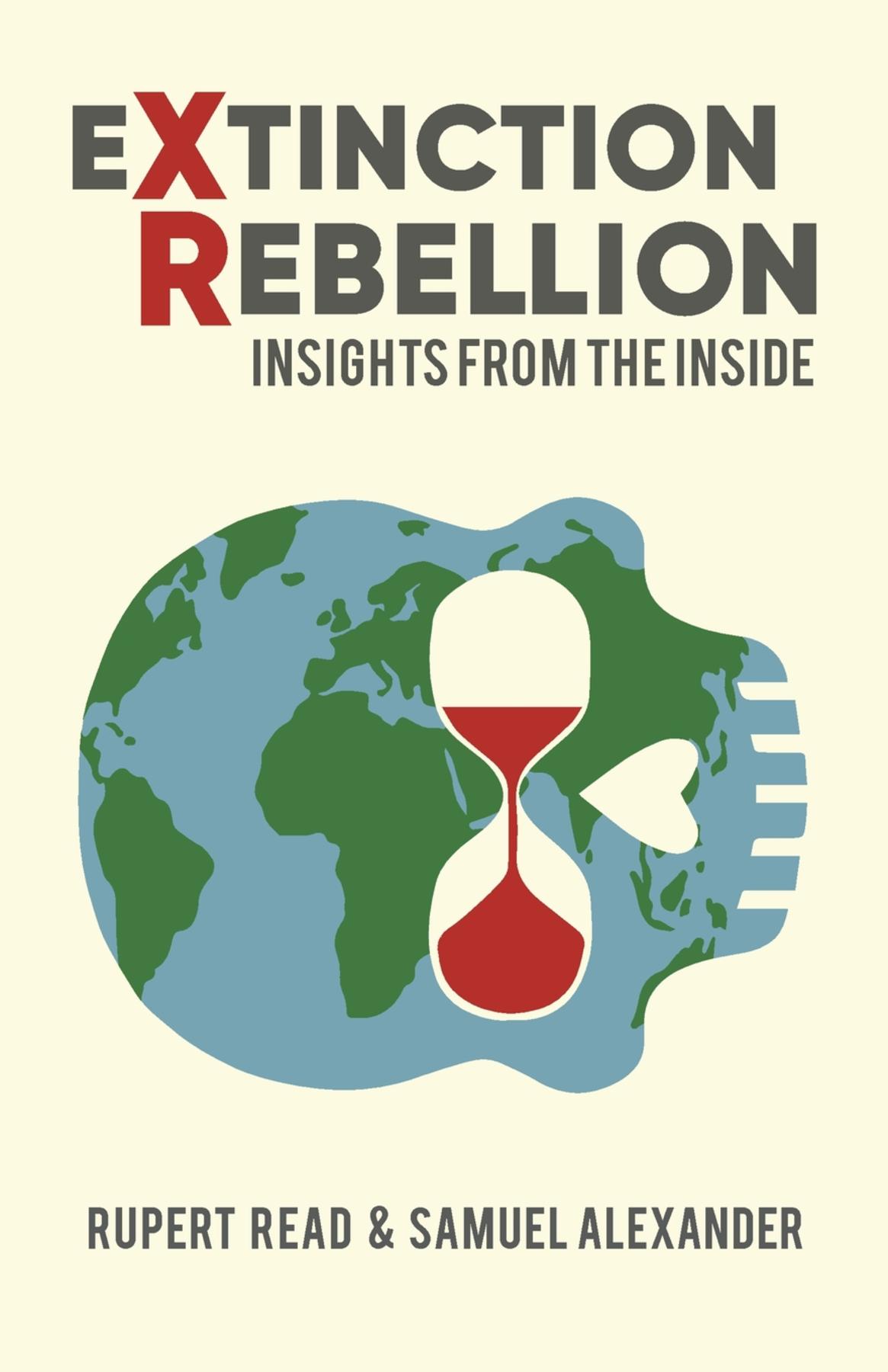
Extinction Rebellion 'Rupert Read and Samuel Alexander take us deep inside the debates, tactics, and passion that have bound Extinction Rebellion together from its founding days, bringing us radical reflections from the frontlines of rebellion. If you want to understand the movement that is finally waking us up, read this book.' - Kate Raworth, author of Doughnut Economics: Seven Ways to Think Like a 21st-Century Economist 'Invaluable reflections and next-step ideas right from the heart of arguably the most inspiring and important movement of the twenty first century'. - Mike Berners-Lee, author of There is no planet B: A Handbook for the Make or Break Years 'Everyone should read this book. It is short, and impassioned, but full of important information: above all an honest and practical plea for us to seize the moment for change urgently. It is inspirational. Please, for all our sakes, read it, and take its timely words to heart.' - Iain McGilchrist, author of The Master and his Emissary: The Divided Brain and the Making of the Western World 'The ecological emergency is the greatest challenge that humanity has ever faced, and Extinction Rebellion may be our last best chance to address it. Read this inside story of the most important social movement of our time.' - David Loy, author of Ecodharma: Buddhist Teachings for the Ecological Crisis 'From the eruption of XR in our lives in late 2018, Rupert Read has been closely involved in the organisation as an advisor, influencer, spokesperson and occasional critic. These fascinating essays read like dispatches from the front line, crackling with urgency, tempered by timely reflections, and reminding us of the scale of the challenge ahead as we rebuild our shattered, post-coronavirus economies.' - Jonathon Porritt, former Director of the UK Sustainable Development Commission and of Friends of the Earth 'Activist-philosopher Rupert Read, a key thinker of Extinction Rebellion, has collected a treasure trove of foundational essays, documenting the transformational XR UK experience, that will be immensely valuable for activists around the world trying to replicate that achievement. The book is incisive, pertinent, self-critical, well-written, and, in the XR way, occasionally cheeky. Anyone concerned with combating the broader wave of ecological collapse - that led to the pandemic and that is rising behind it - should read Read.' - Ken Ward, protagonist in the documentary The Reluctant Radical 'Most of us like to watch movies about people saving the world but too rarely do we even try to do it ourselves. Despite the situation so obviously calling for it! This is a book about what might well turn out to be the most important social movement in history.' - David Graeber, author of The Democracy Project: A History, a Crisis, a Movement POLITICAL SCIENCE,Political Process,General
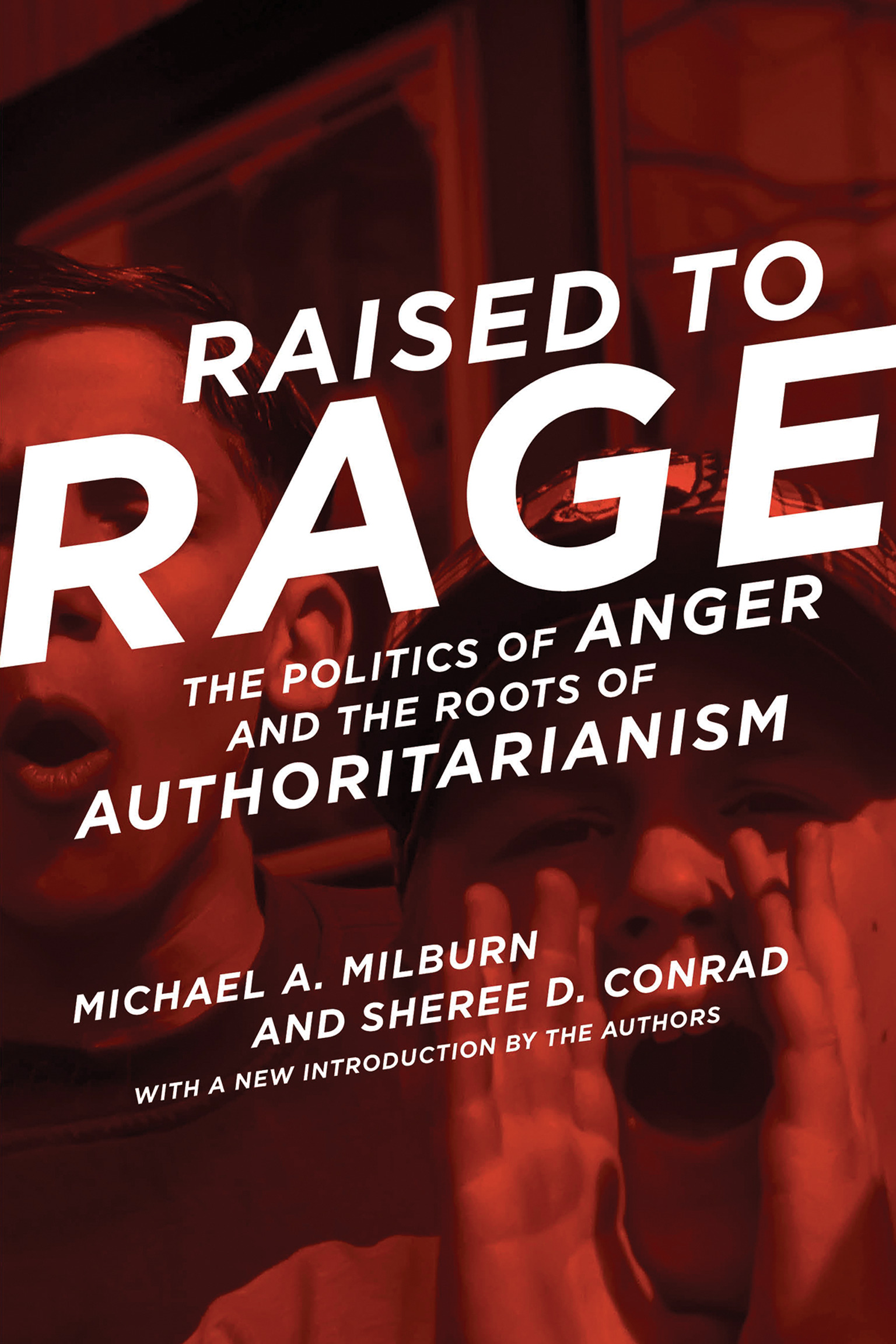
Raised to Rage An argument that voter anger and authoritarian political attitudes can be traced to the displacement of anger, fear, and helplessness. Politicians routinely amplify and misdirect voters' anger and resentment to win their support. Opportunistic candidates encourage supporters to direct their anger toward Mexicans, Muslims, women, protestors, and others, rather than the true socioeconomic causes of their discontent. This book offers a compelling and novel explanation for political anger and the roots of authoritarian political attitudes. In Raised to Rage, Michael Milburn and Sheree Conrad connect vociferous opposition to immigrants, welfare, and abortion to the displacement of anger, fear, and helplessness. These emotions may be triggered by real economic and social instability, but Milburn and Conrad's research shows that the original source is in childhood brutalization or some other emotional trauma. Their research also shows that frequent experiences of physical punishment in childhood increase support in adulthood for punitive public policies, distorting the political process. Originally published in 1996, reprinted now with a new introduction by the authors that updates the empirical evidence and connects it to the current political situation, this book offers a timely consideration of a paradox in American politics: why voters are convinced by campaign rhetoric, exaggeration, and scapegoating to vote against their own interests. POLITICAL SCIENCE,Political Process,General
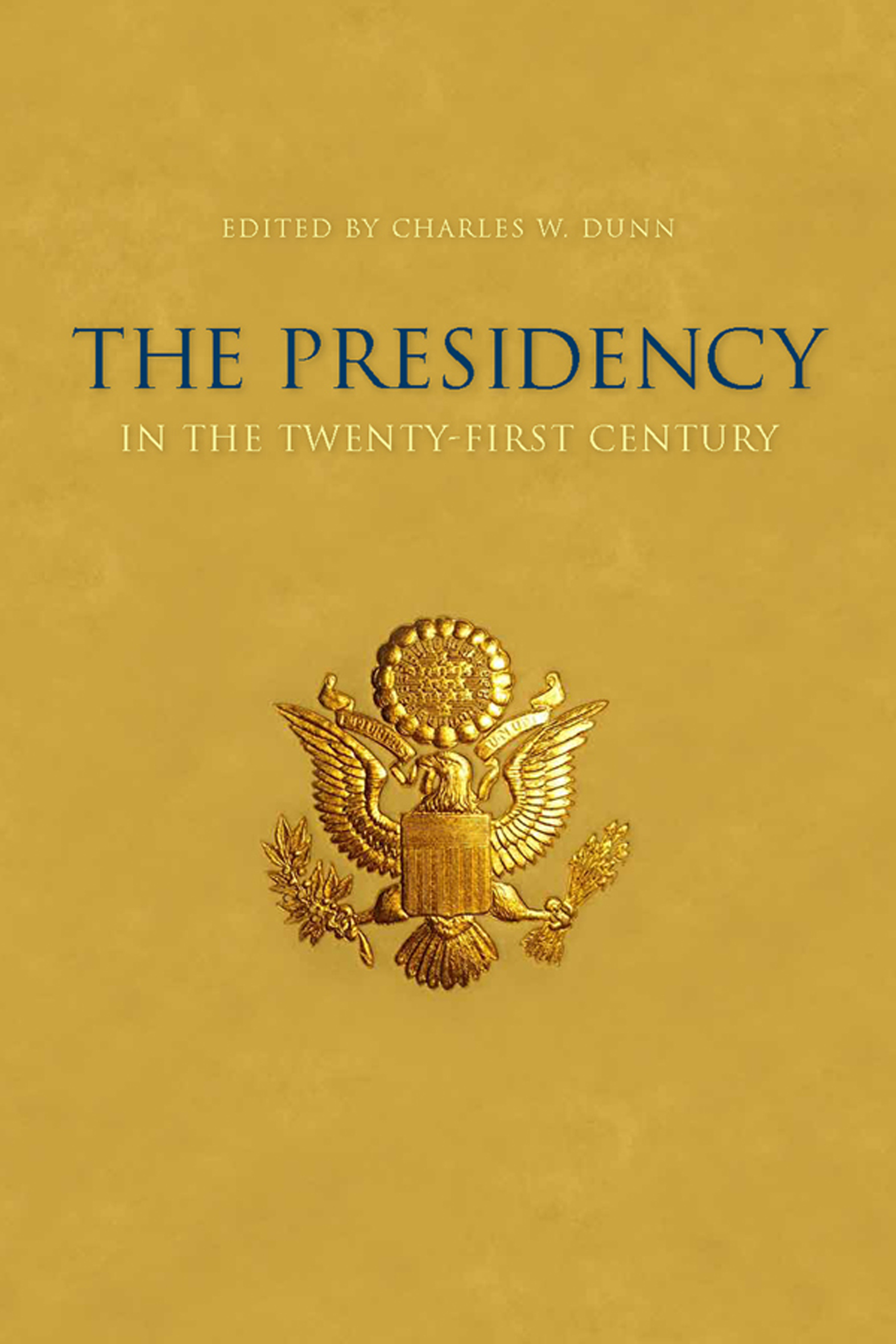
The Presidency in the Twenty-First Century As the most prominent figure of the U.S. government, the president is under constant scrutiny from both his colleagues and the American people. Questions about the proper role of the president have been especially prevalent in the media during the current economic crisis. The Presidency in the Twenty-first Century explores the growth of presidential power, investigating its social, political, and economic impact on America's present and future. Editor Charles W. Dunn and a team of the nation's leading political scientists examine a variety of topics, from the link between campaigning and governing to trends in presidential communication with the public. The book discusses the role of the presidency in a government designed to require cooperation with Congress and how this relationship is further complicated by the expectations of the public. Several contributors take a closer look at the Obama administration in light of President George W. Bush's emphasis on the unitary executive, a governing style that continues to be highly controversial. Dunn and his contributors provide readers with a thorough analysis of a rapidly changing political role, provoking important questions about the future of America's political system. POLITICAL SCIENCE,Political Process,General
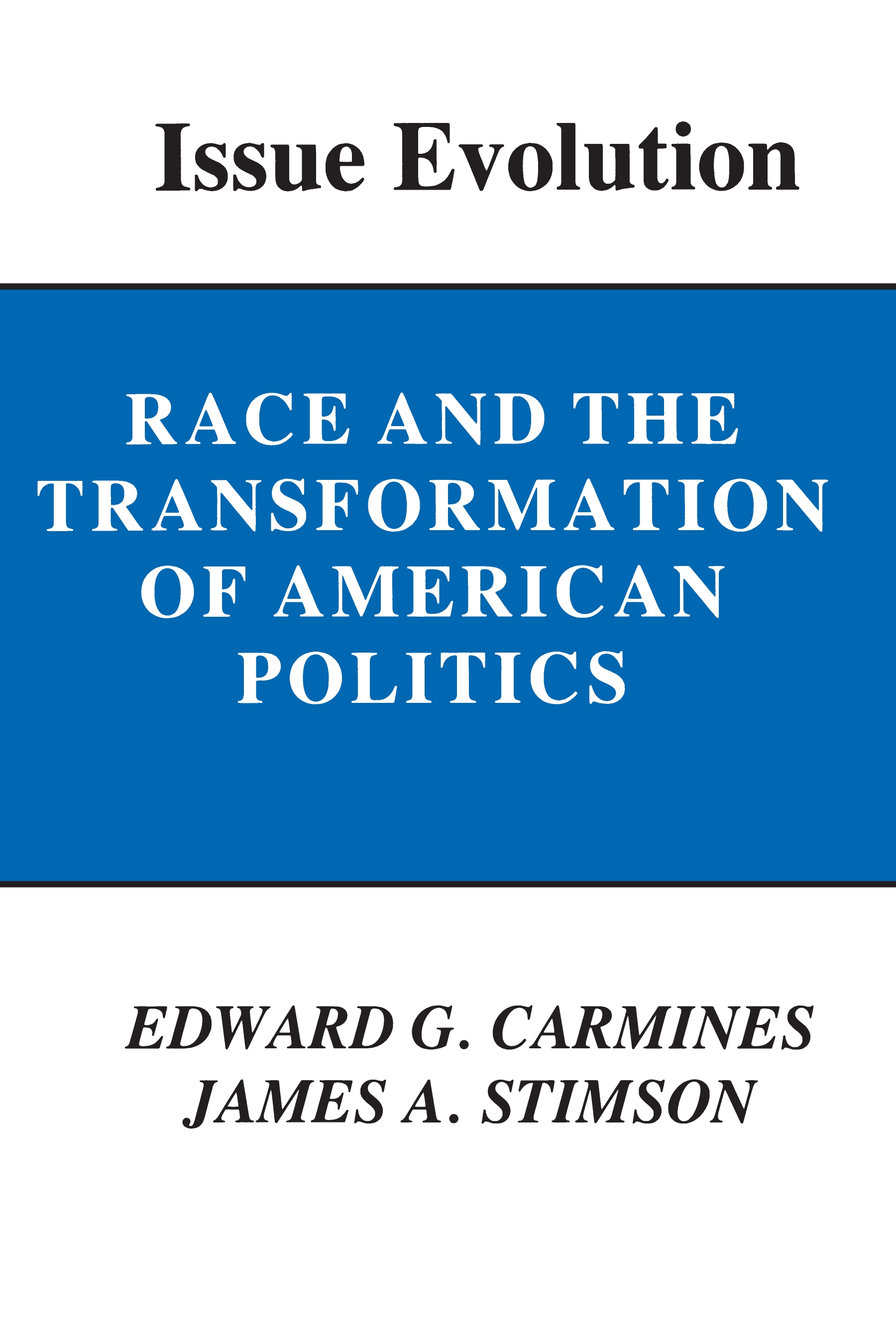
Issue Evolution The description for this book, Issue Evolution: Race and the Transformation of American Politics, will be forthcoming. POLITICAL SCIENCE,Political Process,General
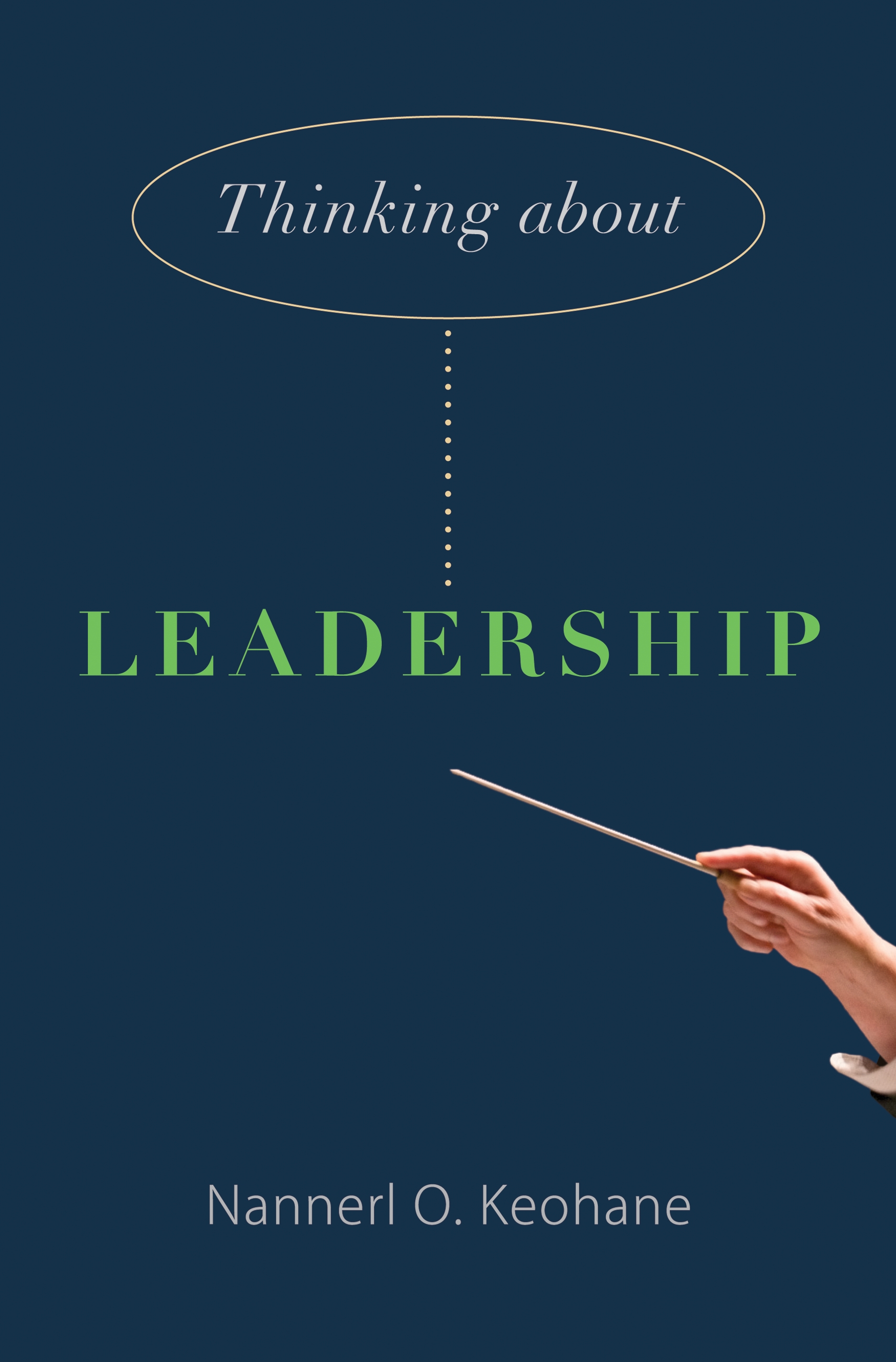
Thinking about Leadership Leadership is essential to collective human endeavor, from setting and accomplishing goals for a neighborhood block association, to running a Fortune 500 company, to mobilizing the energies of a nation. Political philosophers have focused largely on how to prevent leaders from abusing their power, yet little attention has been paid to what it actually feels like to hold power, how leaders go about their work, and how they relate to the people they lead. In Thinking about Leadership, Nannerl Keohane draws on her experience as the first woman president of Duke University and former president of Wellesley College, as well as her expertise as a leading political theorist, to deepen our understanding of what leaders do, how and why they do it, and the pitfalls and challenges they face. Keohane engages readers in a series of questions that shed light on every facet of leadership. She considers the traits that make a good leader, including sound judgment, decisiveness, integrity, social skill, and intelligence; the role that gender plays in one's ability to attain and wield power; ethics and morality; the complex relationship between leaders and their followers; and the unique challenges of democratic leadership. Rich with lessons and insights from leaders and political thinkers down through the ages, including Aristotle, Queen Elizabeth I, Franklin D. Roosevelt, and Nelson Mandela, Thinking about Leadership is a must-read for current and future leaders, and for anyone concerned about our prospects for good governance. POLITICAL SCIENCE,Political Process,Leadership
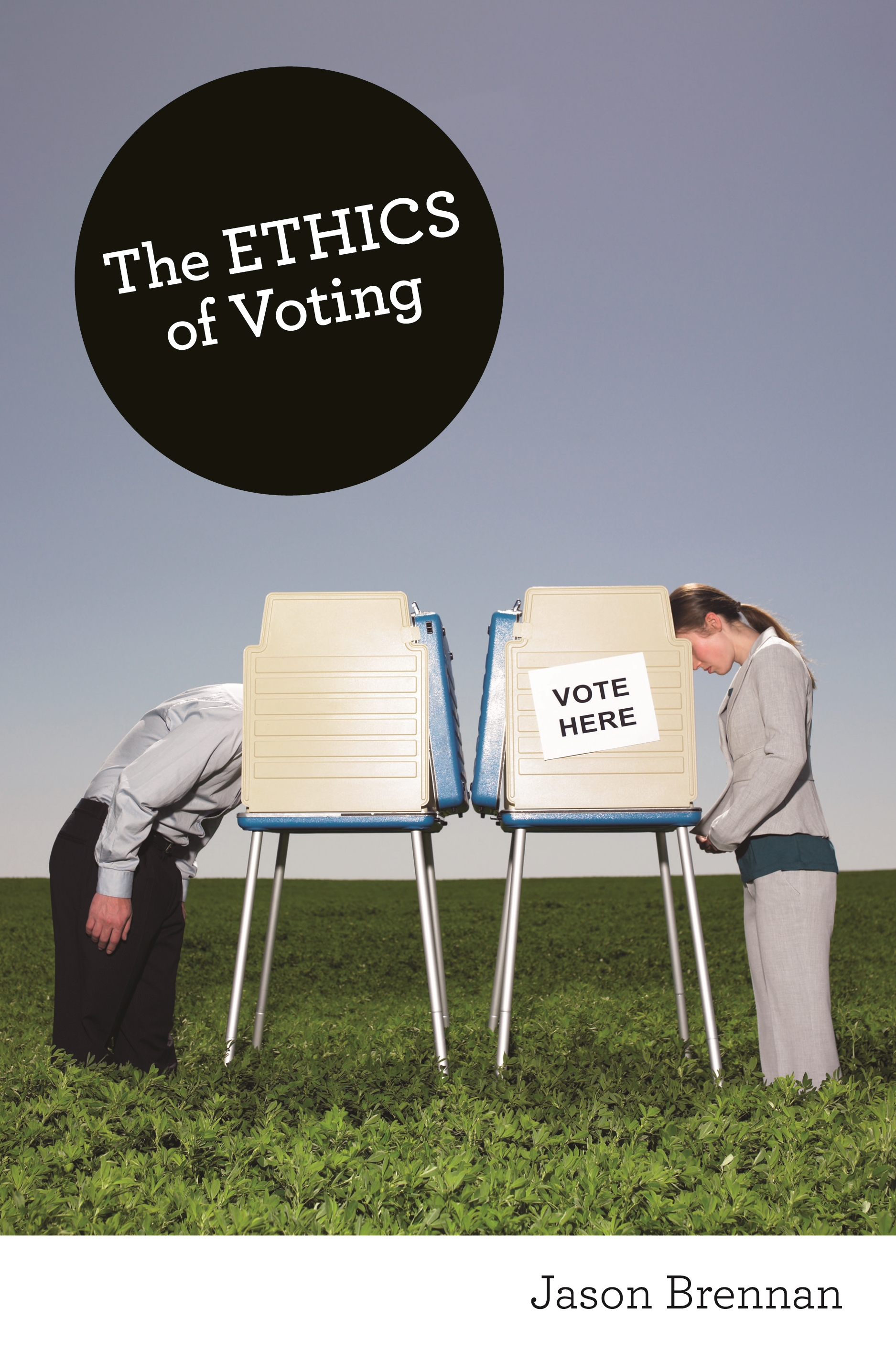
The Ethics of Voting Nothing is more integral to democracy than voting. Most people believe that every citizen has the civic duty or moral obligation to vote, that any sincere vote is morally acceptable, and that buying, selling, or trading votes is inherently wrong. In this provocative book, Jason Brennan challenges our fundamental assumptions about voting, revealing why it is not a duty for most citizens--in fact, he argues, many people owe it to the rest of us not to vote. Bad choices at the polls can result in unjust laws, needless wars, and calamitous economic policies. Brennan shows why voters have duties to make informed decisions in the voting booth, to base their decisions on sound evidence for what will create the best possible policies, and to promote the common good rather than their own self-interest. They must vote well--or not vote at all. Brennan explains why voting is not necessarily the best way for citizens to exercise their civic duty, and why some citizens need to stay away from the polls to protect the democratic process from their uninformed, irrational, or immoral votes. In a democracy, every citizen has the right to vote. This book reveals why sometimes it's best if they don't. In a new afterword, "How to Vote Well," Brennan provides a practical guidebook for making well-informed, well-reasoned choices at the polls. POLITICAL SCIENCE,Political Process,Leadership
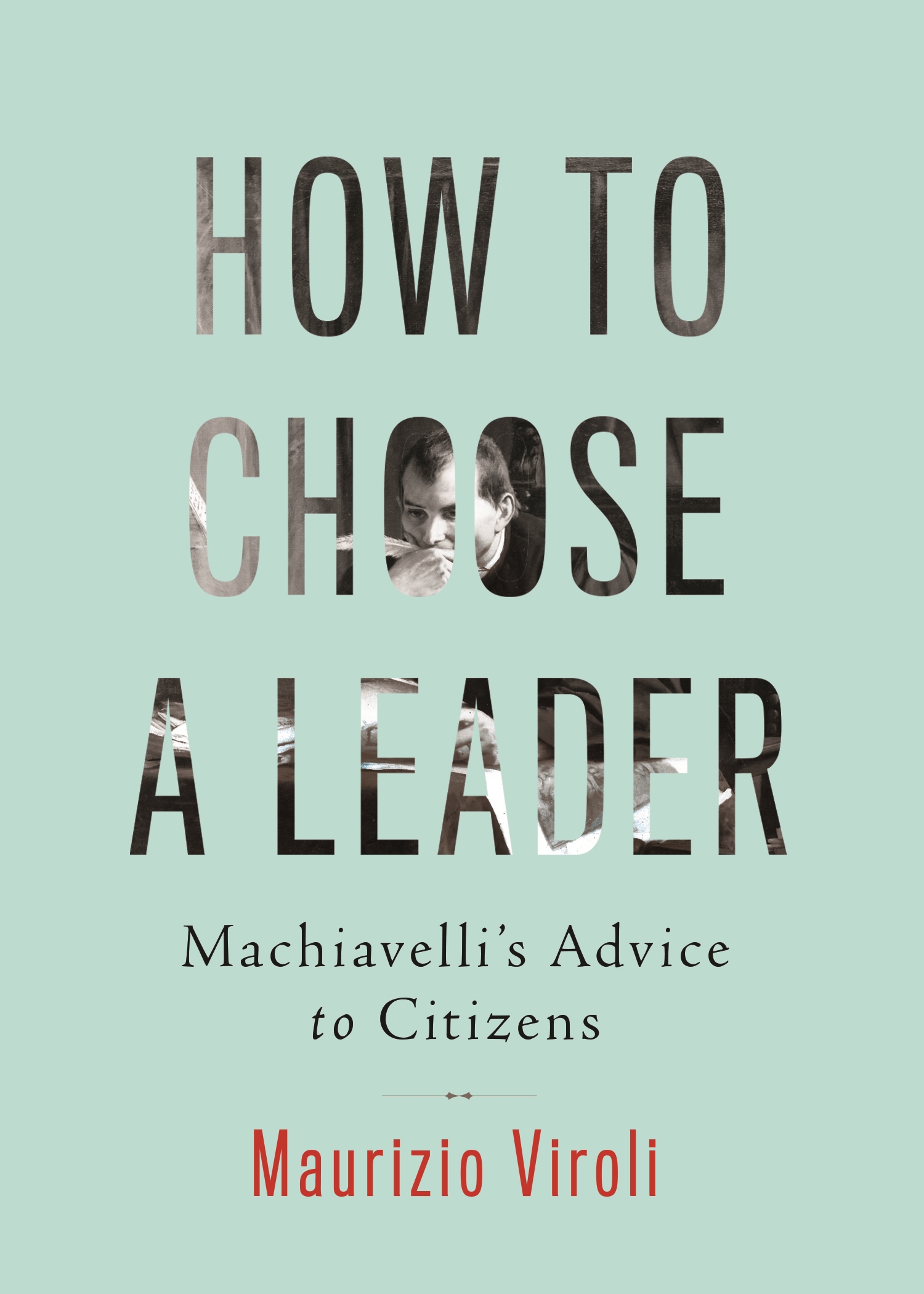
How to Choose a Leader Twenty essential tips for picking great leaders from the father of modern politics One of the greatest political advisers of all time, Niccolò Machiavelli thought long and hard about how citizens could identify great leaders—ones capable of defending and enhancing the liberty, honor, and prosperity of their countries. Drawing on the full range of the Florentine's writings, acclaimed Machiavelli biographer Maurizio Viroli gathers and interprets Machiavelli's timeless wisdom about choosing leaders. The brief and engaging result is a new kind of Prince—one addressed to citizens rather than rulers and designed to make you a better voter. Demolishing popular misconceptions that Machiavelli is a cynical realist, the book shows that he believes republics can't survive, let alone thrive, without leaders who are virtuous as well as effective. Among much other valuable advice, Machiavelli says that voters should pick leaders who put the common good above narrower interests and who make fighting corruption a priority, and he explains why the best way to recognize true leaders is to carefully examine their past actions and words. On display throughout are the special insights that Machiavelli gained from long, direct knowledge of real political life, the study of history, and reflection on the political thinkers of antiquity. Recognizing the difference between great and mediocre political leaders is difficult but not at all impossible—with Machiavelli's help. So do your country a favor. Read this book, then vote like Machiavelli would. POLITICAL SCIENCE,Political Process,Leadership
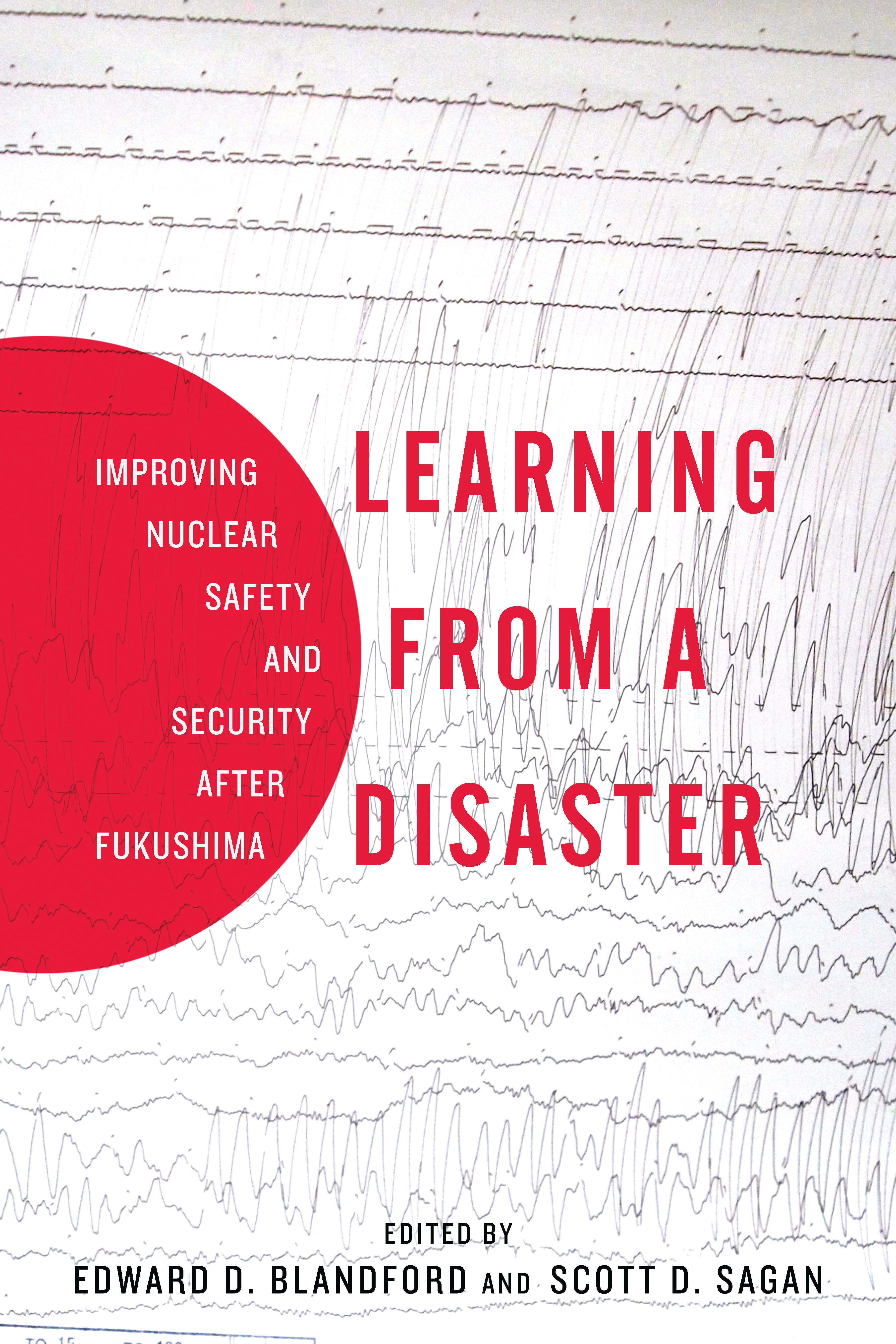
Learning from a Disaster This book—the culmination of a truly collaborative international and highly interdisciplinary effort—brings together Japanese and American political scientists, nuclear engineers, historians, and physicists to examine the Fukushima accident from a new and broad perspective. It explains the complex interactions between nuclear safety risks (the causes and consequences of accidents) and nuclear security risks (the causes and consequences of sabotage or terrorist attacks), exposing the possible vulnerabilities all countries may have if they fail to learn from this accident. The book further analyzes the lessons of Fukushima in comparative perspective, focusing on the politics of safety and emergency preparedness. It first compares the different policies and procedures adopted by various nuclear facilities in Japan and then discusses the lessons learned—and not learned—after major nuclear accidents and incidents in other countries in the past. The book's editors conclude that learning lessons across nations has proven to be very difficult, and they propose new policies to improve global learning after nuclear accidents or attacks. POLITICAL SCIENCE,Political Process,Leadership

A Long Time Coming Since 1984, Newsweek has been renowned for its vivid, in-depth special election coverage of the ordeal of running for the presidency. A year before the election, Newsweek assigns reporters to get inside the campaigns of the Republican and Democratic candidates. Newsweek promises not to publish any information until after the votes are cast, and in exchange, the reporters receive remarkable access. They travel with the candidates, are there at crucial turning points and confidential meetings, and uncover stories not covered in day-to-day reporting. In this book, a compelling narrative by Evan Thomas, Newsweek shares the inside stories from one of the most exciting elections in recent history, illuminating the personalities and events that influenced the outcome, and taking stock of the key players and key issues for the new administration. This will be an absorbing read for anyone interested in American politics. POLITICAL SCIENCE,Political Process,Leadership
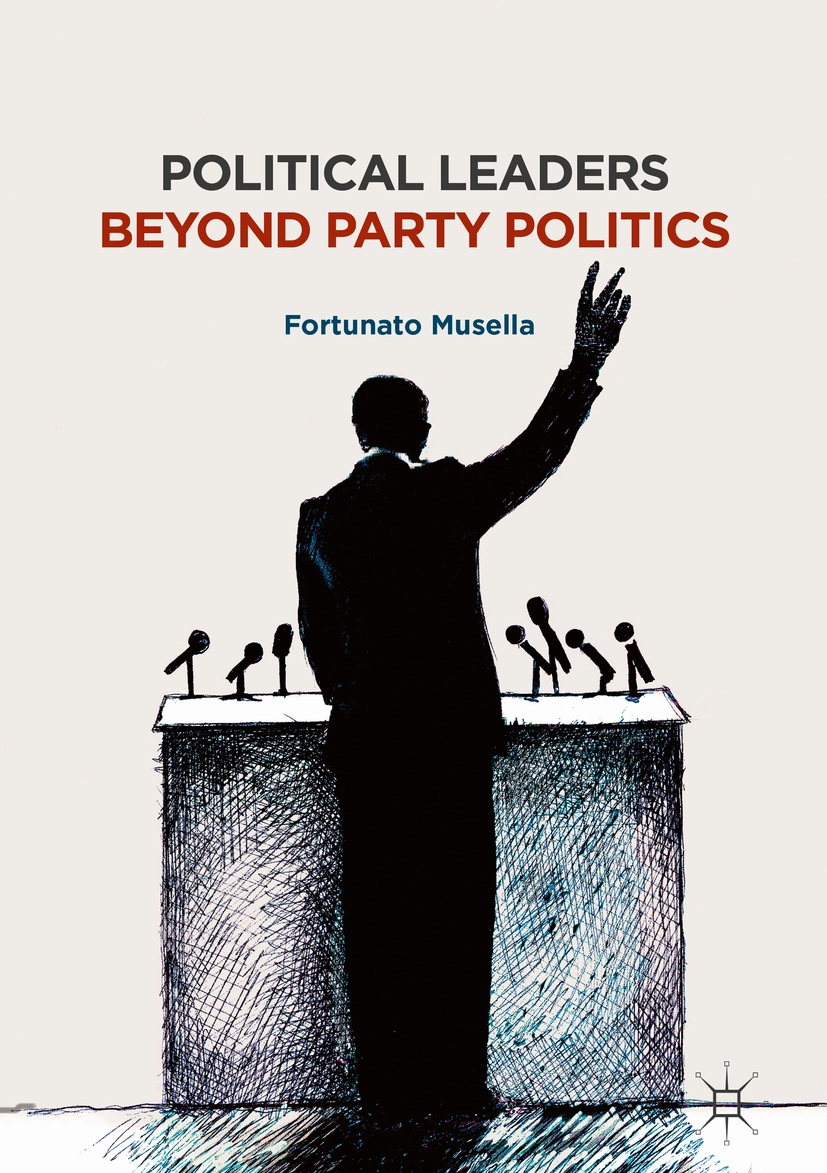
Political Leaders Beyond Party Politics This book studies party leaders from selection to post-presidency. Based on data covering a large set of Western countries, and focusing on the trends of personalisation of politics, the volume is one of the first empirical investigations into how party leaders are elected, how long they stay in office, and whether they enter and guide democratic governments. It also provides novel data on how leaders end their career in a broad and diverse range of business activities. Topics covered include political leaders’ increasing autonomy, their reinforcement of popular legitimation, often through the introduction of direct election by party rank and file, and their grip on party organization. The book will appeal to students and scholars interested in political parties, political leadership, the transformation of democracy, and comparative politics. POLITICAL SCIENCE,Political Process,Leadership

A Duterte Reader A critical analysis of one of the most media-savvy authoritarian rulers of our time, this collection of essays offers an overview of Duterte’s rise to power and actions of his early presidency. With contributions from leading experts on the society and history of the Phillipines, The Duterte Reader is necessary reading for anyone needing to contextualize and understand the history and social forces that have shaped contemporary Philippine politics. POLITICAL SCIENCE,Political Process,Leadership

When We Fight, We Win Same-sex marriage, #BlackLivesMatter, the DREAM Act, the People’s Climate March, End the New Jim Crow, Occupy Wall Street, the fight for a $15 minimum wagethese are just a few of the remarkable movements that have blossomed in the past decade, a most fertile and productive era of activism. Now, in a visually rich and deeply inspiring book, the leaders and activists of these and other movements distill their wisdom, sharing lessons of what makesand what hinderstransformative social change. Longtime social activist Greg Jobin-Leeds joins forces with AgitArte, a collective of artists and organizers, to capture the stories, philosophy, tactics, and art of today’s leading social change movements. When We Fight, We Win! weaves together interviews with today’s most successful activists and artists from across the country and beyondincluding Patrisse Cullors-Brignac, Bill McKibben, Clayton Thomas-Muller, Karen Lewis, Favianna Rodriguez, Rea Carey, and Gaby Pacheco, among otherswith narrative recountings of strategies and campaigns alongside full-color photos. It includes a foreword by Rinku Sen and an afterword by Antonia Darder. When We Fight, We Win! will give a whole generation of readers the chance to celebrate and benefit from a remarkable decade of activisma decade that shows just how ripe these times are for social transformation. POLITICAL SCIENCE,Political Process,Leadership
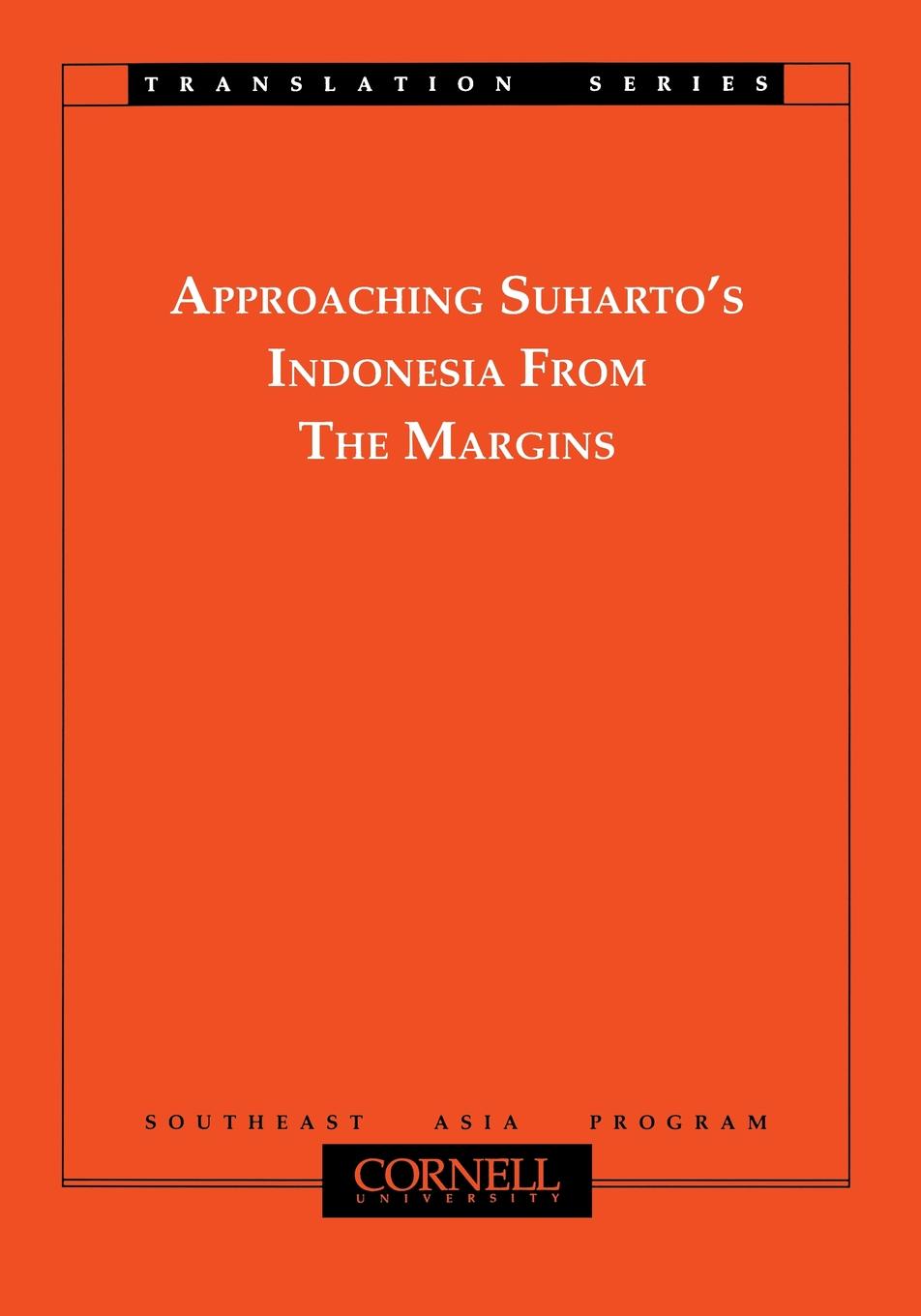
Approaching Suharto's Indonesia from the Margins This text is the fourth and final volume in a series of essays by Japanese scholars of Southeast Asia. The authors examine issues such as the political styles and methodologies of Suharto's New Order government, the economic development of Indonesia... POLITICAL SCIENCE,Political Process,Leadership
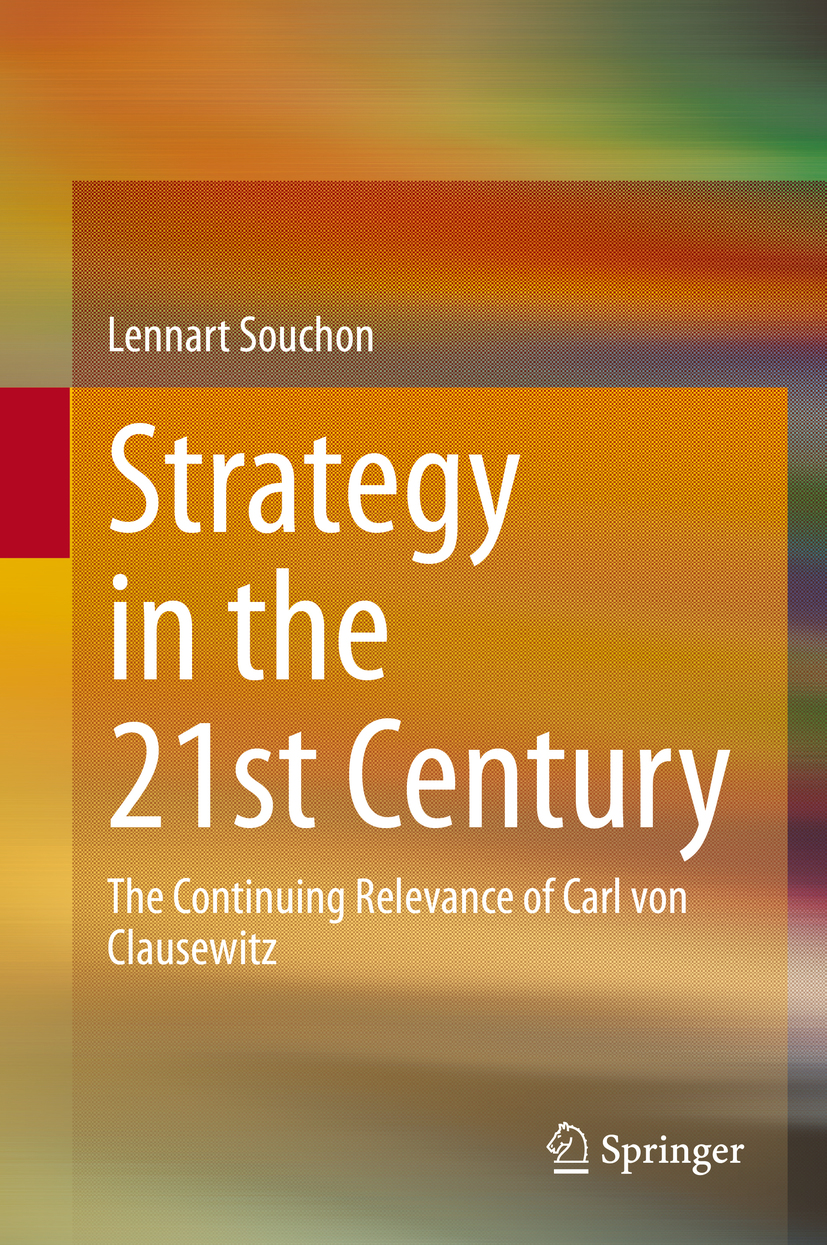
Strategy in the 21st Century This book presents a detailed discussion of Clausewitz's principal lines of thought and methods of implementation. It elaborates on his main objective of laying a foundation for the education of up-and-coming creative, knowledgeable and experienced future leaders. The book encourages reflection and study in strategic thinking in order to transform knowledge into genuine capability. The book explores the question of what a twenty-first-century decision-maker can learn from these strategic lines of thought. It bridges the gap between philosophical theory and strategic interaction in conflicts with an equal opponent. Readers learn to understand and employ the clash of wills, attack and defence, and friction, and in essence the necessary virtues of a strategic commander. The findings presented help to identify the essential features in complex decision-making situations and developing possible courses of strategic action from a holistic standpoint. As such, the book is a must read for strategists, business practitioners, and scholars of political leadership and management interested in a better understanding of strategy and decision-making. POLITICAL SCIENCE,Political Process,Leadership

The Republican Noise Machine In The Republican Noise Machine, David Brock skillfully documents perhaps the most important but least understood political development of the last thirty years: how the Republican Right has won political power and hijacked public discourse in the United States. Brock, a former right-wing insider and the author of the New York Times bestseller Blinded by the Right, uses his keen understanding of the strategies, tactics, financing, and personalities of the American right wing to demonstrate how the once-fringe phenomenon of right-wing media has all but subsumed the regular media conversation, shaped the national consciousness, and turned American politics sharply to the right. Brock documents how in the last several decades the GOP built a powerful media machine--newspapers and magazines, think tanks, talk radio networks, op-ed columnists, the FOX News Channel, Christian Right broadcasting, book publishers, and high-traffic internet sites--to sell conservatism to the public and discredit its opponents. This unabashedly biased multibillion-dollar communications empire disregards journalistic ethics and universal standards of fairness and accuracy, manufacturing "news" that is often bought and paid for by a tight network of corporate-backed foundations and old family fortunes. By dissecting the appeal, techniques, and reach of the booming right-wing media market, Brock demonstrates that it is largely based on bigotry, ignorance, and emotional manipulation closely tied to America’s longstanding cultural divisions and the buying power of anti-intellectual traditionalists. From the disputed 2000 presidential election to the war with Iraq to the political battles of 2004, Brock's penetrating analysis of right-wing media theories and methodology reveals that the Republican Right views the media as an extension of a broader struggle for political power. By tracing the political impact of right-wing media, Brock shows how disproportionate conservative influence in the media is integrally linked to the Republican Right’s current domination of all three branches of government, to the propping up of the Bush administration, and to the inability of Democrats to voice their opposition to this political sea change or to compete on an even playing field. As only an ex-conservative intimately familiar with the imperatives of the American right wing could, David Brock suggests ways in which concerned Americans can begin to redress the conservative ascendancy and cut through the propagandistic fog. Writing with verve and deep insight, he reaches far beyond typical bromides about media bias to produce an invaluable account of the rise of right-wing media and its political consequences. Promising to be the political book of the year, The Republican Noise Machine will transform the raging yet heretofore unsatisfying debate over the politics of the media for years to come. POLITICAL SCIENCE,Political Process,Media & Internet
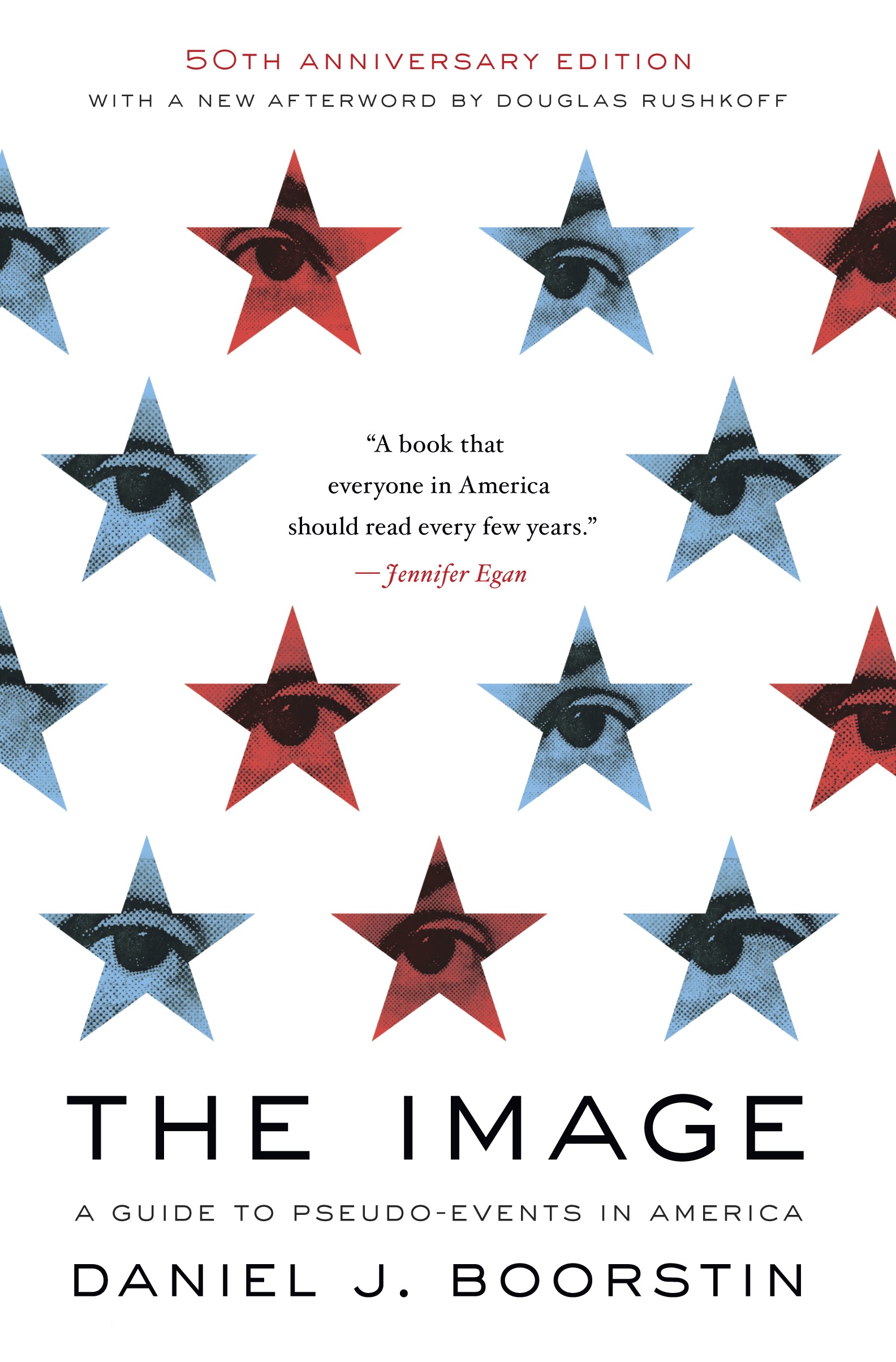
The Image First published in 1962, this wonderfully provocative book introduced the notion of “pseudo-events”—events such as press conferences and presidential debates, which are manufactured solely in order to be reported—and the contemporary definition of celebrity as “a person who is known for his well-knownness.” Since then Daniel J. Boorstin’s prophetic vision of an America inundated by its own illusions has become an essential resource for any reader who wants to distinguish the manifold deceptions of our culture from its few enduring truths. POLITICAL SCIENCE,Political Process,Media & Internet
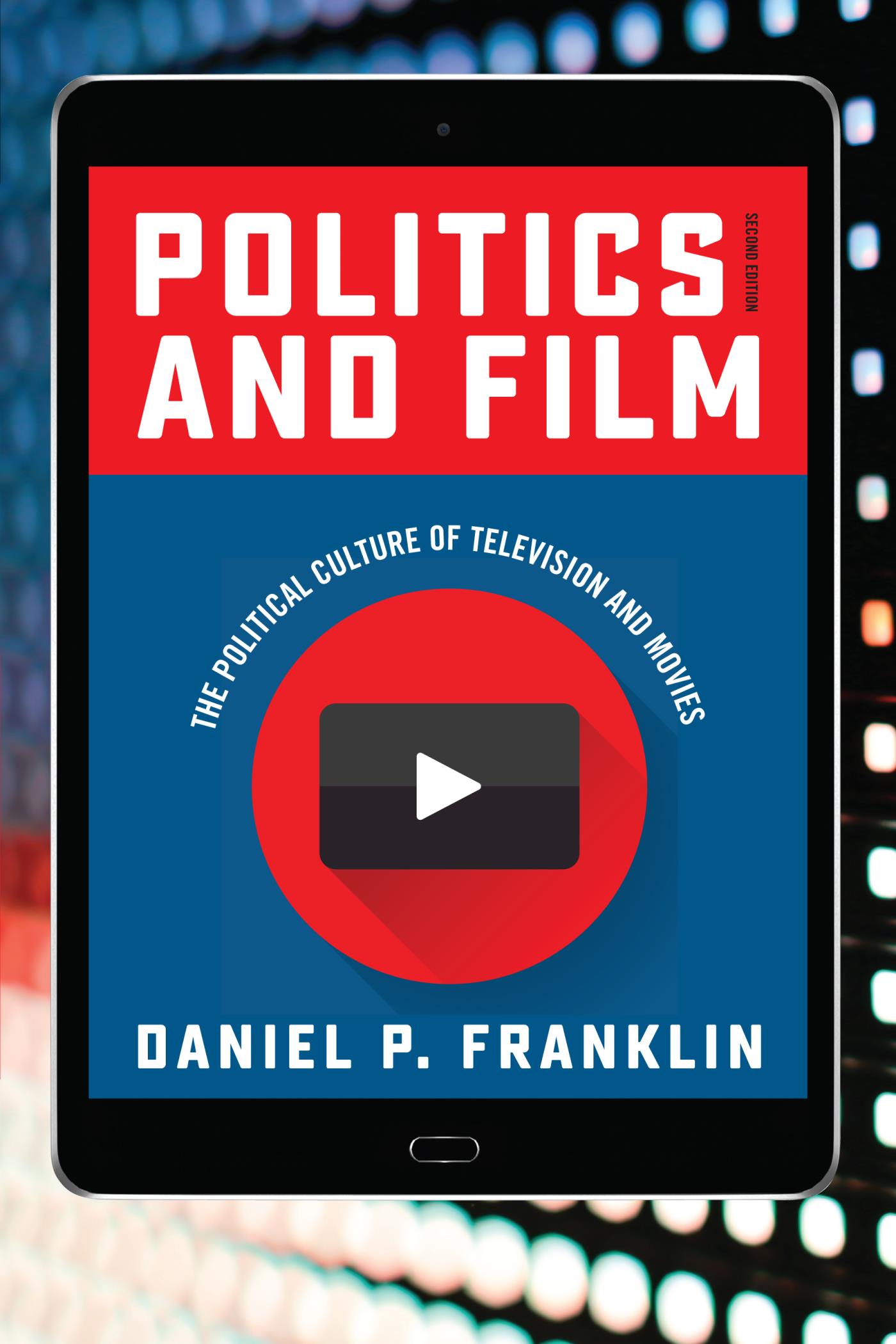
Politics and Film Politics and Film examines popular movies and television shows as indicators of social and political trends to explore the political culture of the United States. POLITICAL SCIENCE,Political Process,Media & Internet
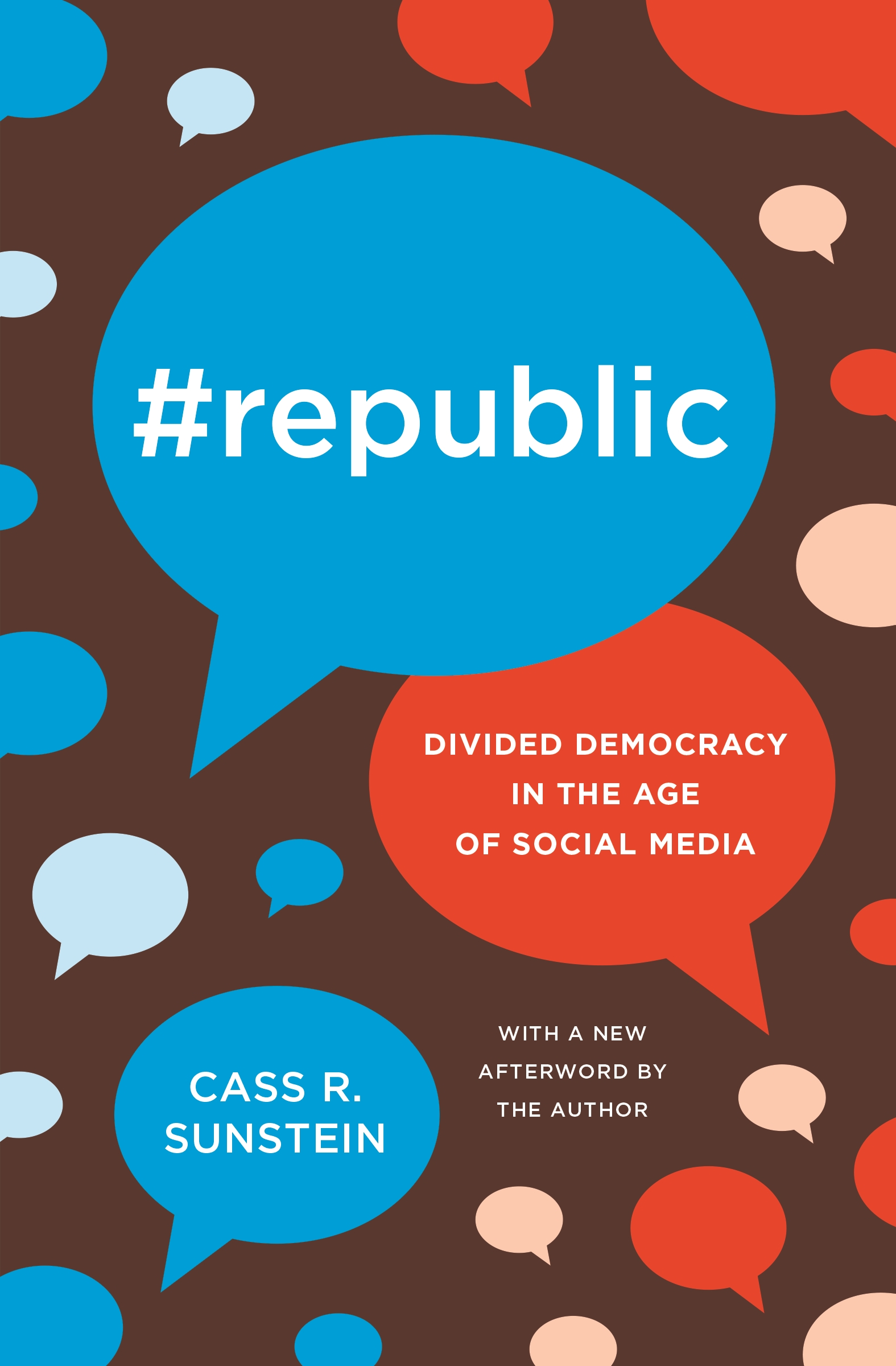
#Republic From the New York Times bestselling author of Nudge and The World According to Star Wars, a revealing account of how today's Internet threatens democracy—and what can be done about it As the Internet grows more sophisticated, it is creating new threats to democracy. Social media companies such as Facebook can sort us ever more efficiently into groups of the like-minded, creating echo chambers that amplify our views. It's no accident that on some occasions, people of different political views cannot even understand one another. It's also no surprise that terrorist groups have been able to exploit social media to deadly effect. Welcome to the age of #Republic. In this revealing book, New York Times bestselling author Cass Sunstein shows how today’s Internet is driving political fragmentation, polarization, and even extremism--and what can be done about it. He proposes practical and legal changes to make the Internet friendlier to democratic deliberation, showing that #Republic need not be an ironic term. Rather, it can be a rallying cry for the kind of democracy that citizens of diverse societies need most. POLITICAL SCIENCE,Political Process,Media & Internet
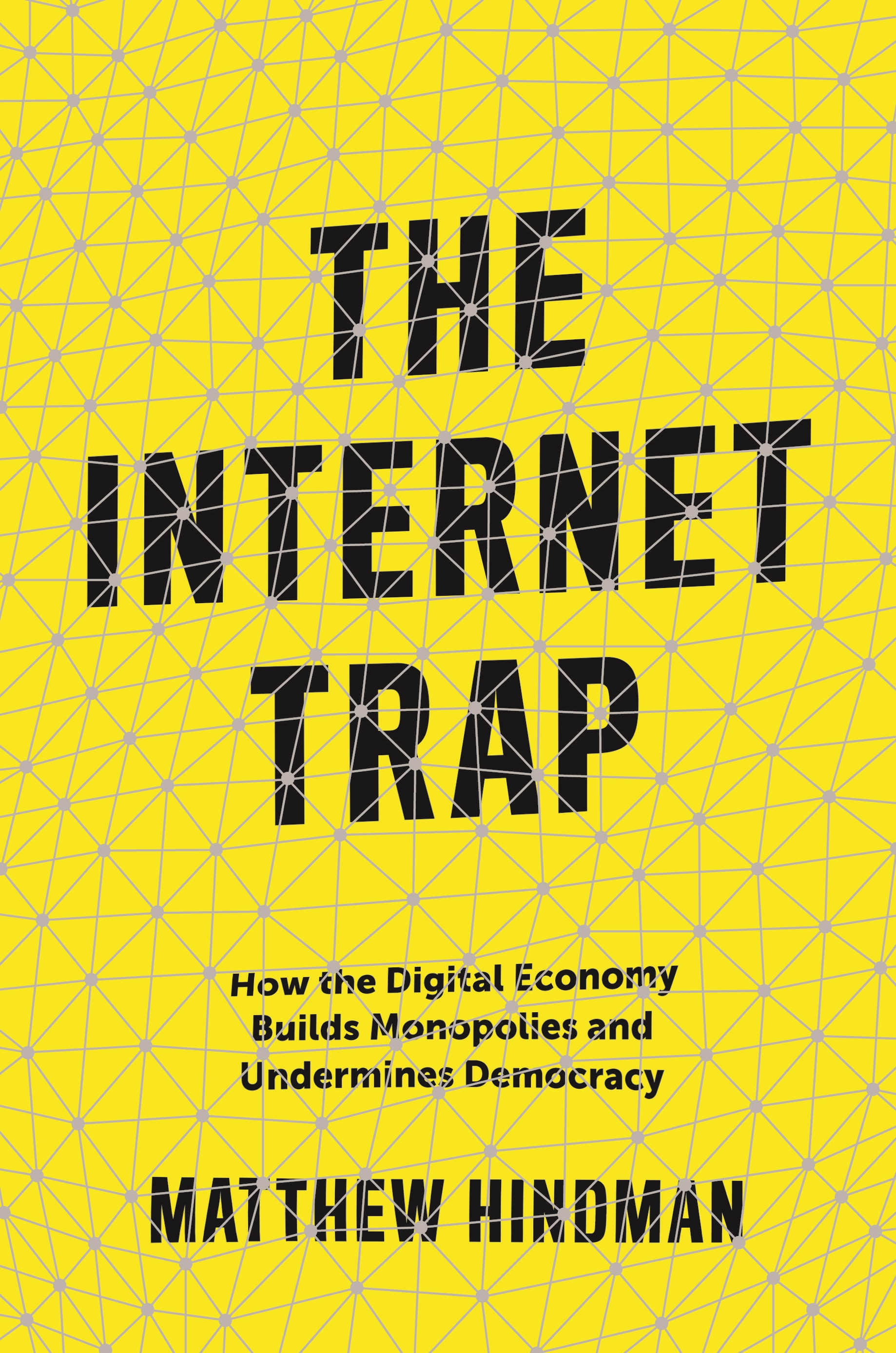
The Internet Trap A book that challenges everything you thought you knew about the online economy The internet was supposed to fragment audiences and make media monopolies impossible. Instead, behemoths like Google and Facebook now dominate the time we spend online—and grab all the profits from the attention economy. The Internet Trap explains how this happened. This provocative and timely book sheds light on the stunning rise of the digital giants and the online struggles of nearly everyone else—and reveals what small players can do to survive in a game that is rigged against them. Matthew Hindman shows how seemingly tiny advantages in attracting users can snowball over time. The internet has not reduced the cost of reaching audiences—it has merely shifted who pays and how. Challenging some of the most enduring myths of digital life, Hindman explains why the internet is not the postindustrial technology that has been sold to the public, how it has become mathematically impossible for grad students in a garage to beat Google, and why net neutrality alone is no guarantee of an open internet. He also explains why the challenges for local digital news outlets and other small players are worse than they appear and demonstrates what it really takes to grow a digital audience and stay alive in today’s online economy. The Internet Trap shows why, even on the internet, there is still no such thing as a free audience. POLITICAL SCIENCE,Political Process,Media & Internet

The Political Effects of Entertainment Media This book provides theory and empirical research on entertainment media’s effects on political perspectives. Included are experimental and survey research on the impact of shows such as Game of Thrones , House of Cards , and The Colbert Report , the genre of science fiction, and villain and leader character types. POLITICAL SCIENCE,Political Process,Media & Internet

Zucked The New York Times bestseller about a noted tech venture capitalist, early mentor to Mark Zuckerberg, and Facebook investor, who wakes up to the serious damage Facebook is doing to our society - and sets out to try to stop it. If you had told Roger McNamee even three years ago that he would soon be devoting himself to stopping Facebook from destroying our democracy, he would have howled with laughter. He had mentored many tech leaders in his illustrious career as an investor, but few things had made him prouder, or been better for his fund's bottom line, than his early service to Mark Zuckerberg. Still a large shareholder in Facebook, he had every good reason to stay on the bright side. Until he simply couldn't. ZUCKED is McNamee's intimate reckoning with the catastrophic failure of the head of one of the world's most powerful companies to face up to the damage he is doing. It's a story that begins with a series of rude awakenings. First there is the author's dawning realization that the platform is being manipulated by some very bad actors. Then there is the even more unsettling realization that Zuckerberg and Sheryl Sandberg are unable or unwilling to share his concerns, polite as they may be to his face. And then comes the election of Donald Trump, and the emergence of one horrific piece of news after another about the malign ends to which the Facebook platform has been put. To McNamee's shock, even still Facebook's leaders duck and dissemble, viewing the matter as a public relations problem. Now thoroughly alienated, McNamee digs into the issue, and fortuitously meets up with some fellow travelers who share his concern, and help him sharpen its focus. Soon he and a dream team of Silicon Valley technologists are charging into the fray, to raise consciousness about the existential threat of Facebook, and the persuasion architecture of the attention economy more broadly -- to our public health and to our political order. Zucked is both an enthralling personal narrative and a masterful explication of the forces that have conspired to place us all on the horns of this dilemma. This is the story of a company and its leadership, but it's also a larger tale of a business sector unmoored from normal constraints, just at a moment of political and cultural crisis, the worst possible time to be given new tools for summoning the darker angels of our nature and whipping them into a frenzy. Like Jimmy Stewart in Rear Window, Roger McNamee happened to be in the right place to witness a crime, and it took him some time to make sense of what he was seeing and what we ought to do about it. The result of that effort is a wise, hard-hitting, and urgently necessary account that crystallizes the issue definitively for the rest of us. POLITICAL SCIENCE,Political Process,Media & Internet
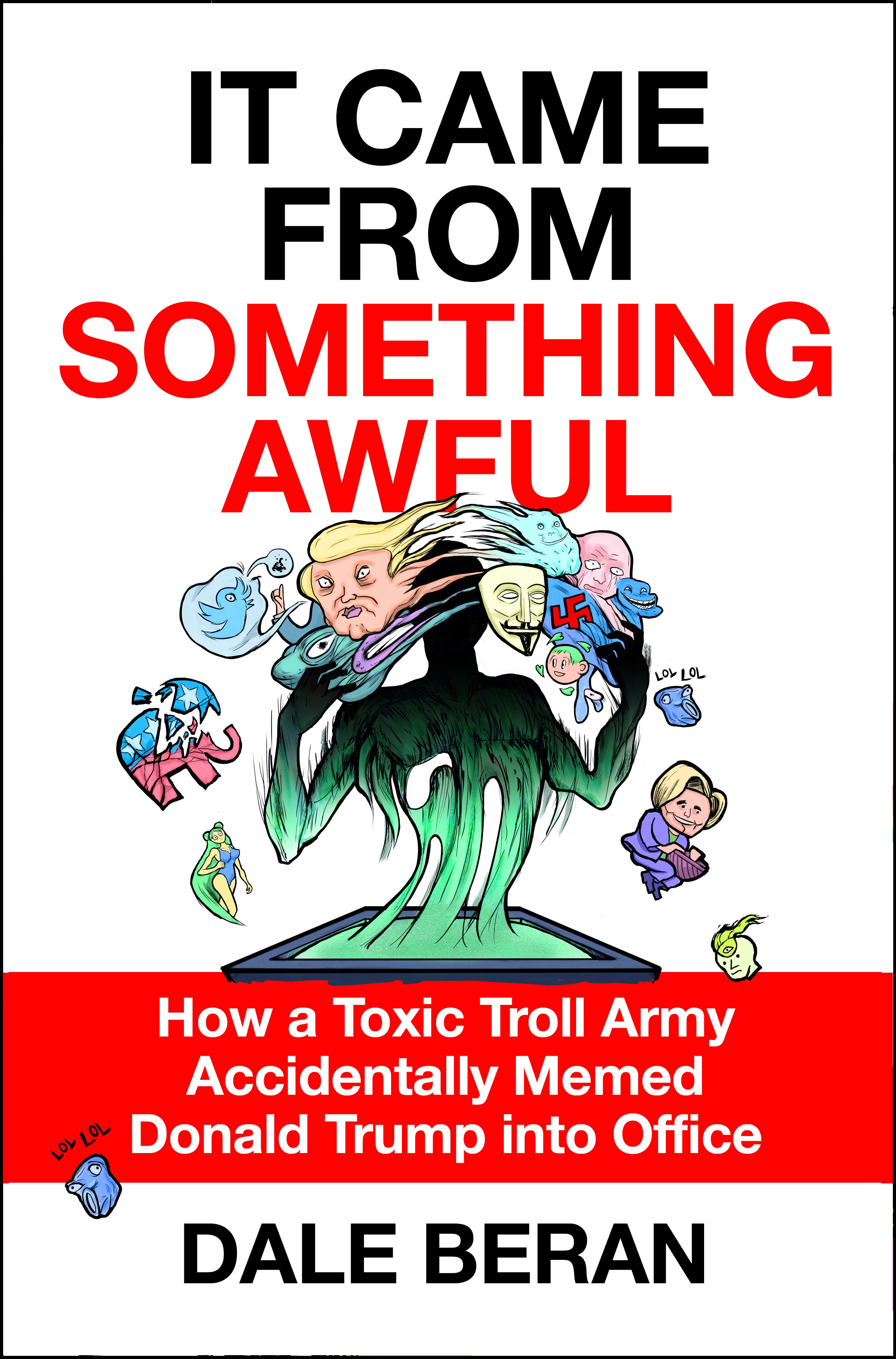
It Came from Something Awful How 4chan and 8chan fuel white nationalism, inspire violence, and infect politics. The internet has transformed the ways we think and act, and by consequence, our politics. The most impactful recent political movements on the far left and right started with massive online collectives of teenagers. Strangely, both movements began on the same website: an anime imageboard called 4chan.org. It Came from Something Awful is the fascinating and bizarre story of sites like 4chan and 8chan and their profound effect on youth counterculture. Dale Beran has observed the anonymous messageboard community's shifting activities and interests since the beginning. Sites like 4chan and 8chan are microcosms of the internet itself—simultaneously at the vanguard of contemporary culture, politics, comedy and language, and a new low for all of the above. They were the original meme machines, mostly frequented by socially awkward and disenfranchised young men in search of a place to be alone together. During the recession of the late 2000’s, the memes became political. 4chan was the online hub of a leftist hacker collective known as Anonymous and a prominent supporter of the Occupy Wall Street movement. But within a few short years, the site’s ideology spun on its axis; it became the birthplace and breeding ground of the alt-right. In It Came from Something Awful, Beran uses his insider’s knowledge and natural storytelling ability to chronicle 4chan's strange journey from creating rage-comics to inciting riots to—according to some—memeing Donald Trump into the White House. POLITICAL SCIENCE,Political Process,Media & Internet
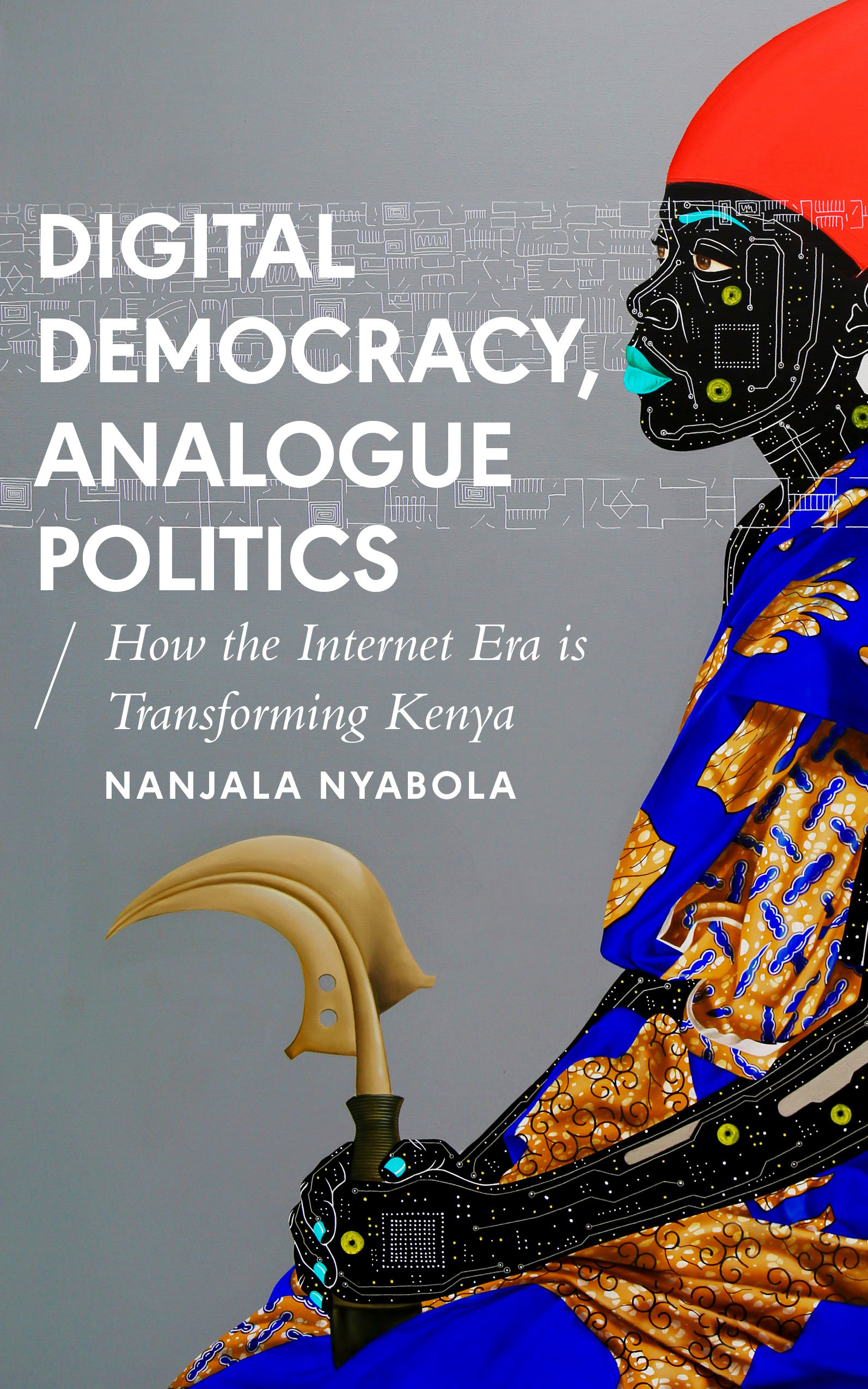
Digital Democracy, Analogue Politics A fascinating account of how the digital age has impacted Kenyan politics, and the consequences for understanding the role of social media in democracies across Africa, and beyond. POLITICAL SCIENCE,Political Process,Media & Internet

Hate Inc. Part tirade, part confessional from the celebrated Rolling Stone journalist, Hate Inc. reveals that what most people think of as "the news" is, in fact, a twisted wing of the entertainment business In this characteristically turbocharged new book, celebrated Rolling Stone journalist Matt Taibbi provides an insider's guide to the variety of ways today's mainstream media tells us lies. Part tirade, part confessional, it reveals that what most people think of as "the news" is, in fact, a twisted wing of the entertainment business. In the Internet age, the press have mastered the art of monetizing anger, paranoia, and distrust. Taibbi, who has spent much of his career covering elections in which this kind of manipulative activity is most egregious, provides a rich taxonomic survey of American political journalism's dirty tricks. Heading into a 2020 election season that promises to be a Great Giza Pyramid Complex of invective and digital ugliness, Hate Inc. will be an invaluable antidote to the hidden poisons dished up by those we rely on to tell us what is happening in the world. POLITICAL SCIENCE,Political Process,Media & Internet
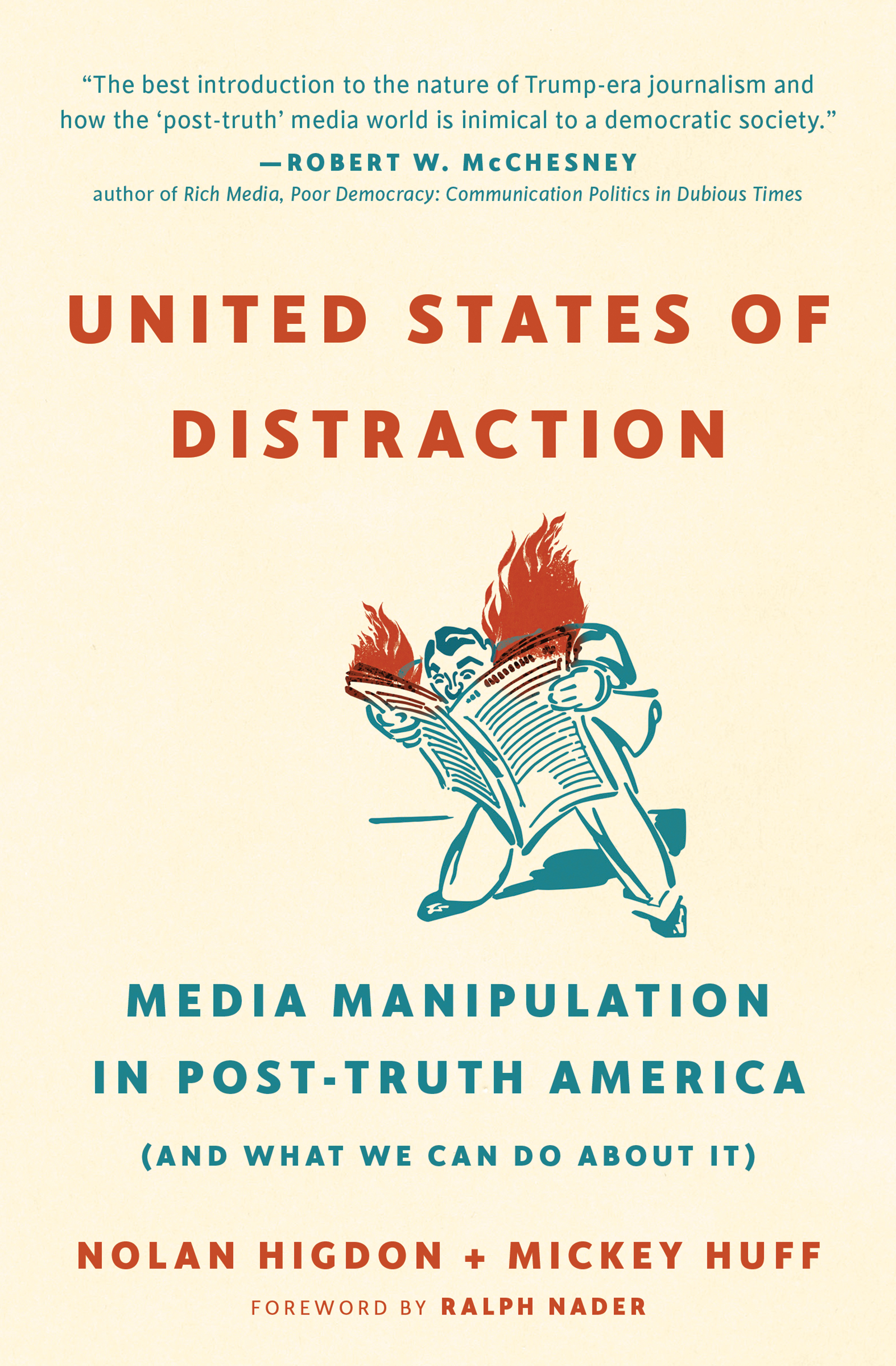
United States of Distraction A provocative critique of how manipulation of media gives rise to disinformation, intolerance, and divisiveness, and what can be done to change direction. POLITICAL SCIENCE,Political Process,Media & Internet
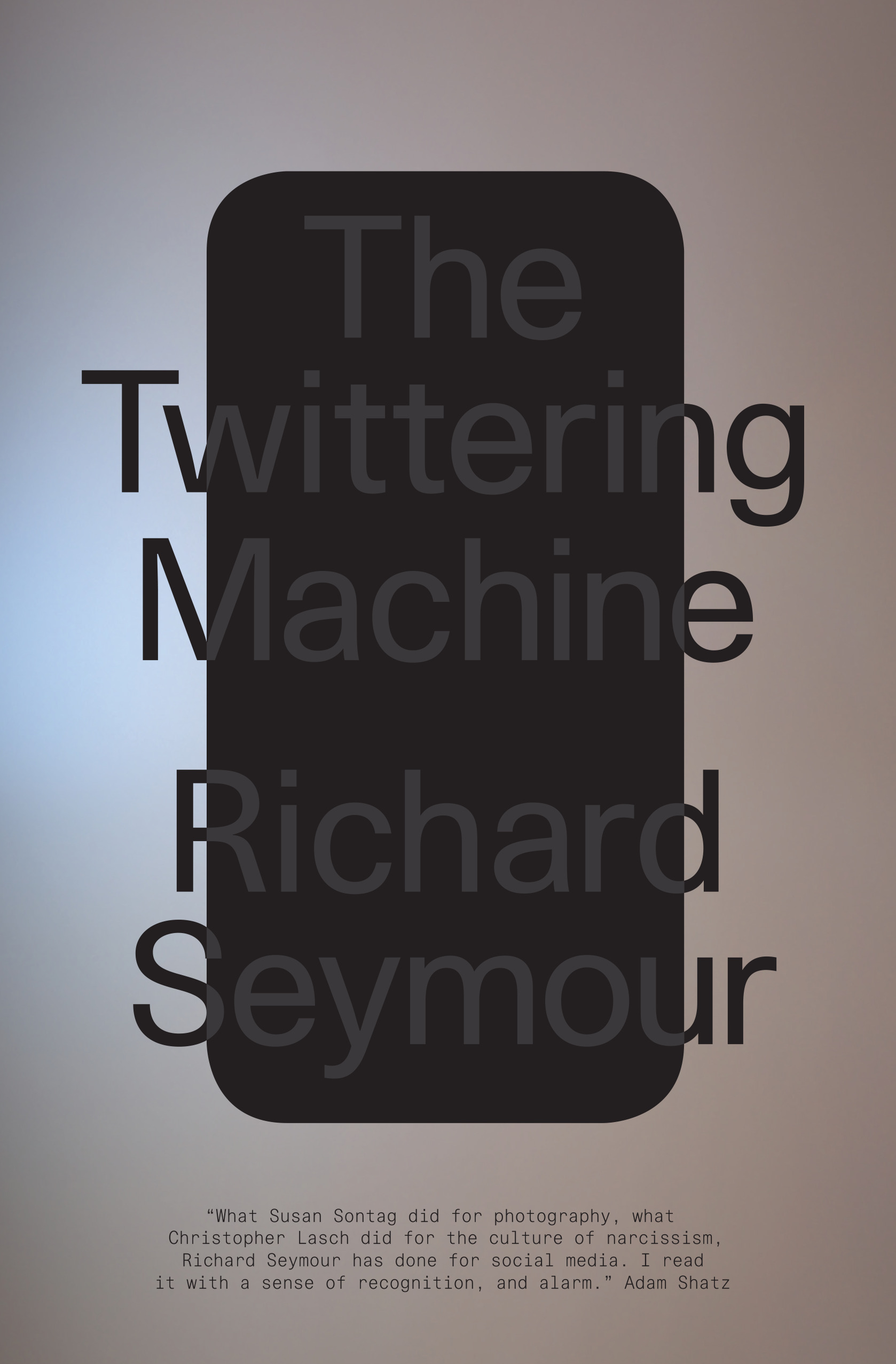
The Twittering Machine A brilliant probe into the political and psychological effects of our changing relationship with social media Former social media executives tell us that the system is an addiction-machine. We are users, waiting for our next hit as we like, comment and share. We write to the machine as individuals, but it responds by aggregating our fantasies, desires and frailties into data, and returning them to us as a commodity experience. The Twittering Machine is an unflinching view into the calamities of digital life: the circus of online trolling, flourishing alt-right subcultures, pervasive corporate surveillance, and the virtual data mines of Facebook and Google where we spend considerable portions of our free time. In this polemical tour de force, Richard Seymour shows how the digital world is changing the ways we speak, write, and think. Through journalism, psychoanalytic reflection and insights from users, developers, security experts and others, Seymour probes the human side of the machine, asking what we’re getting out of it, and what we’re getting into. Social media held out the promise that we could make our own history–to what extent did we choose the nightmare that it has become? POLITICAL SCIENCE,Political Process,Media & Internet
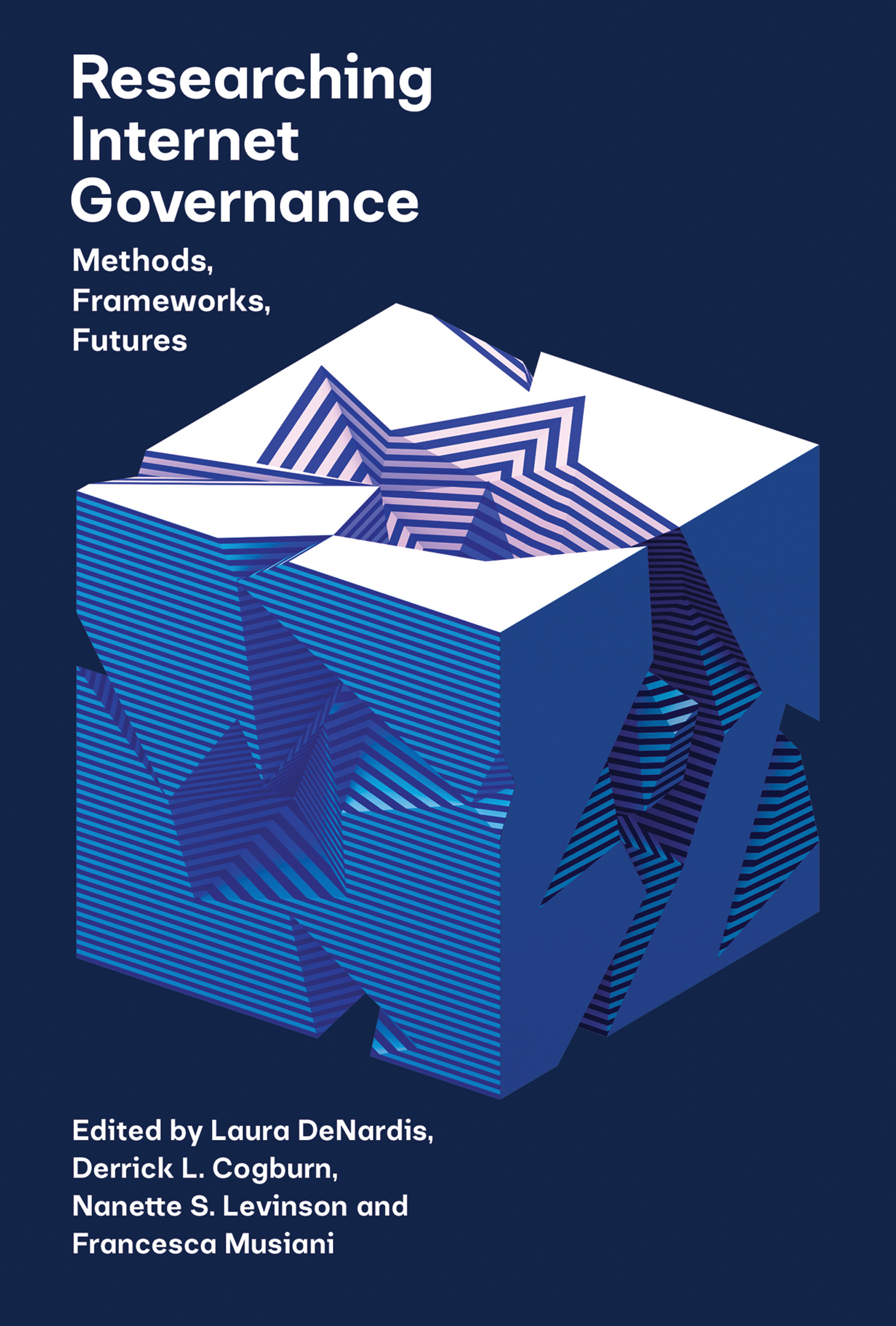
Researching Internet Governance Scholars from a range of disciplines discuss research methods, theories, and conceptual approaches in the study of internet governance. The design and governance of the internet has become one of the most pressing geopolitical issues of our era. The stability of the economy, democracy, and the public sphere are wholly dependent on the stability and security of the internet. Revelations about election hacking, facial recognition technology, and government surveillance have gotten the public's attention and made clear the need for scholarly research that examines internet governance both empirically and conceptually. In this volume, scholars from a range of disciplines consider research methods, theories, and conceptual approaches in the study of internet governance. POLITICAL SCIENCE,Political Process,Media & Internet

The Politicization of Mumsnet The Politicization of Mumsnet investigates the growing politicization of this parenting discussion forum and its use by politicians to influence middle-class women in the UK. POLITICAL SCIENCE,Political Process,Media & Internet
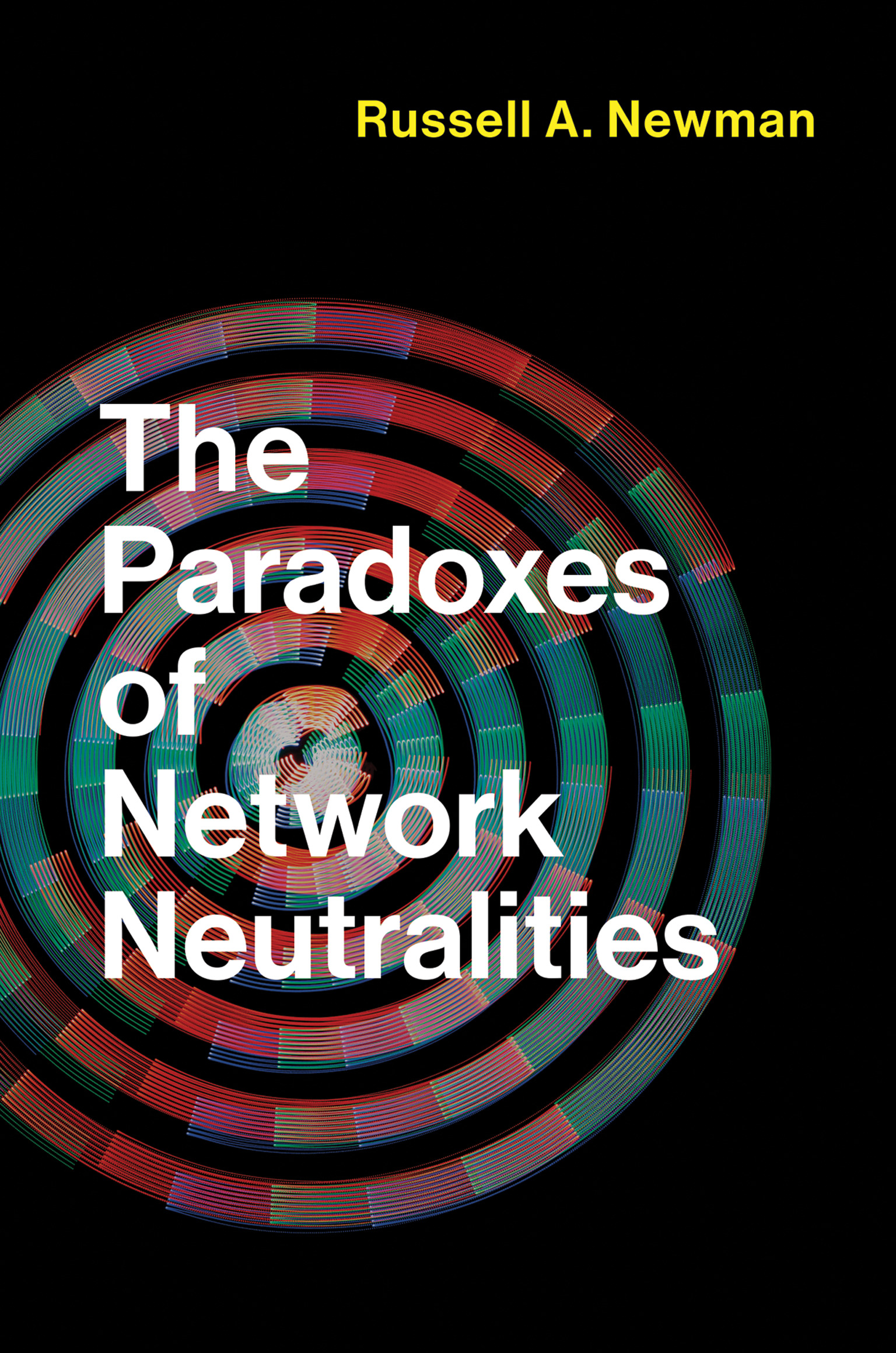
The Paradoxes of Network Neutralities An argument that the movement for network neutrality was of a piece with its neoliberal environment, solidifying the continued existence of a commercially driven internet. Media reform activists rejoiced in 2015 when the FCC codified network neutrality, approving a set of Open Internet rules that prohibitedproviders from favoring some content and applications over others—only to have their hopes dashed two years later when the agency reversed itself. In this book, Russell Newman offers a unique perspective on these events, arguing that the movement for network neutrality was of a piece with its neoliberal environment rather than counter to it; perversely, it served to solidify the continued existence of a commercially dominant internet and even emergent modes of surveillance and platform capitalism. Going beyond the usual policy narrative of open versus closed networks, or public interest versus corporate power, Newman uses network neutrality as a lens through which to examine the ways that neoliberalism renews and reconstitutes itself, the limits of particular forms of activism, and the shaping of future regulatory processes and policies. Newman explores the debate's roots in the 1990s movement for open access, the transition to network neutrality battles in the 2000s, and the terms in which these battles were fought. By 2017, the debate had become unmoored from its own origins, and an emerging struggle against “neoliberal sincerity” points to a need to rethink activism surrounding media policy reform itself. POLITICAL SCIENCE,Political Process,Media & Internet
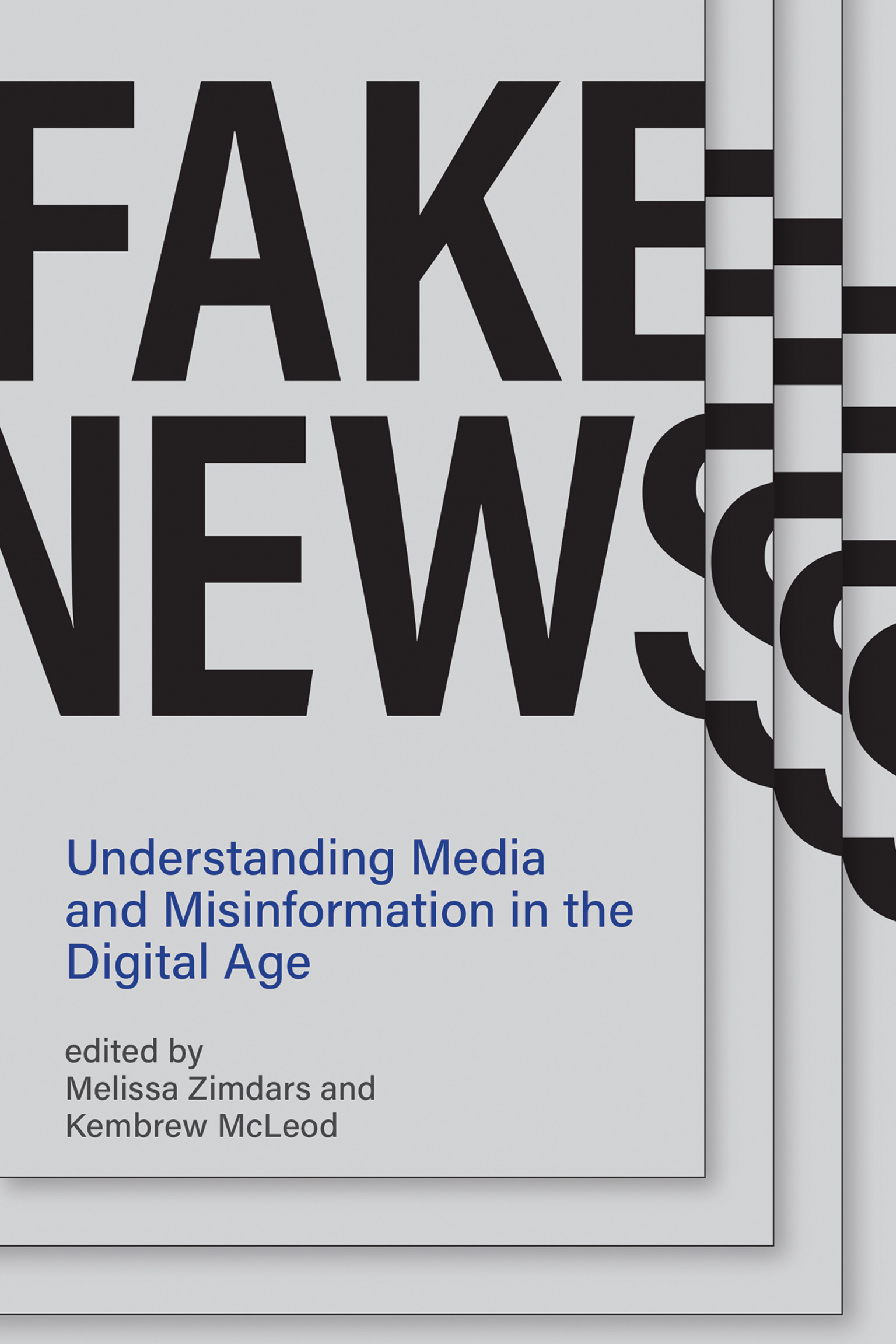
Fake News New perspectives on the misinformation ecosystem that is the production and circulation of fake news. What is fake news? Is it an item on Breitbart, an article in The Onion, an outright falsehood disseminated via Russian bot, or a catchphrase used by a politician to discredit a story he doesn't like? This book examines the real fake news: the constant flow of purposefully crafted, sensational, emotionally charged, misleading or totally fabricated information that mimics the form of mainstream news. Rather than viewing fake news through a single lens, the book maps the various kinds of misinformation through several different disciplinary perspectives, taking into account the overlapping contexts of politics, technology, and journalism. The contributors consider topics including fake news as “disorganized” propaganda; folkloric falsehood in the “Pizzagate” conspiracy; native advertising as counterfeit news; the limitations of regulatory reform and technological solutionism; Reddit's enabling of fake news; the psychological mechanisms by which people make sense of information; and the evolution of fake news in America. A section on media hoaxes and satire features an oral history of and an interview with prankster-activists the Yes Men, famous for parodies that reveal hidden truths. Finally, contributors consider possible solutions to the complex problem of fake news—ways to mitigate its spread, to teach students to find factually accurate information, and to go beyond fact-checking. Contributors Mark Andrejevic, Benjamin Burroughs, Nicholas Bowman, Mark Brewin, Elizabeth Cohen, Colin Doty, Dan Faltesek, Johan Farkas, Cherian George, Tarleton Gillespie, Dawn R. Gilpin, Gina Giotta, Theodore Glasser, Amanda Ann Klein, Paul Levinson, Adrienne Massanari, Sophia A. McClennen, Kembrew McLeod, Panagiotis Takis Metaxas, Paul Mihailidis, Benjamin Peters, Whitney Phillips, Victor Pickard, Danielle Polage, Stephanie Ricker Schulte, Leslie-Jean Thornton, Anita Varma, Claire Wardle, Melissa Zimdars, Sheng Zou POLITICAL SCIENCE,Political Process,Media & Internet
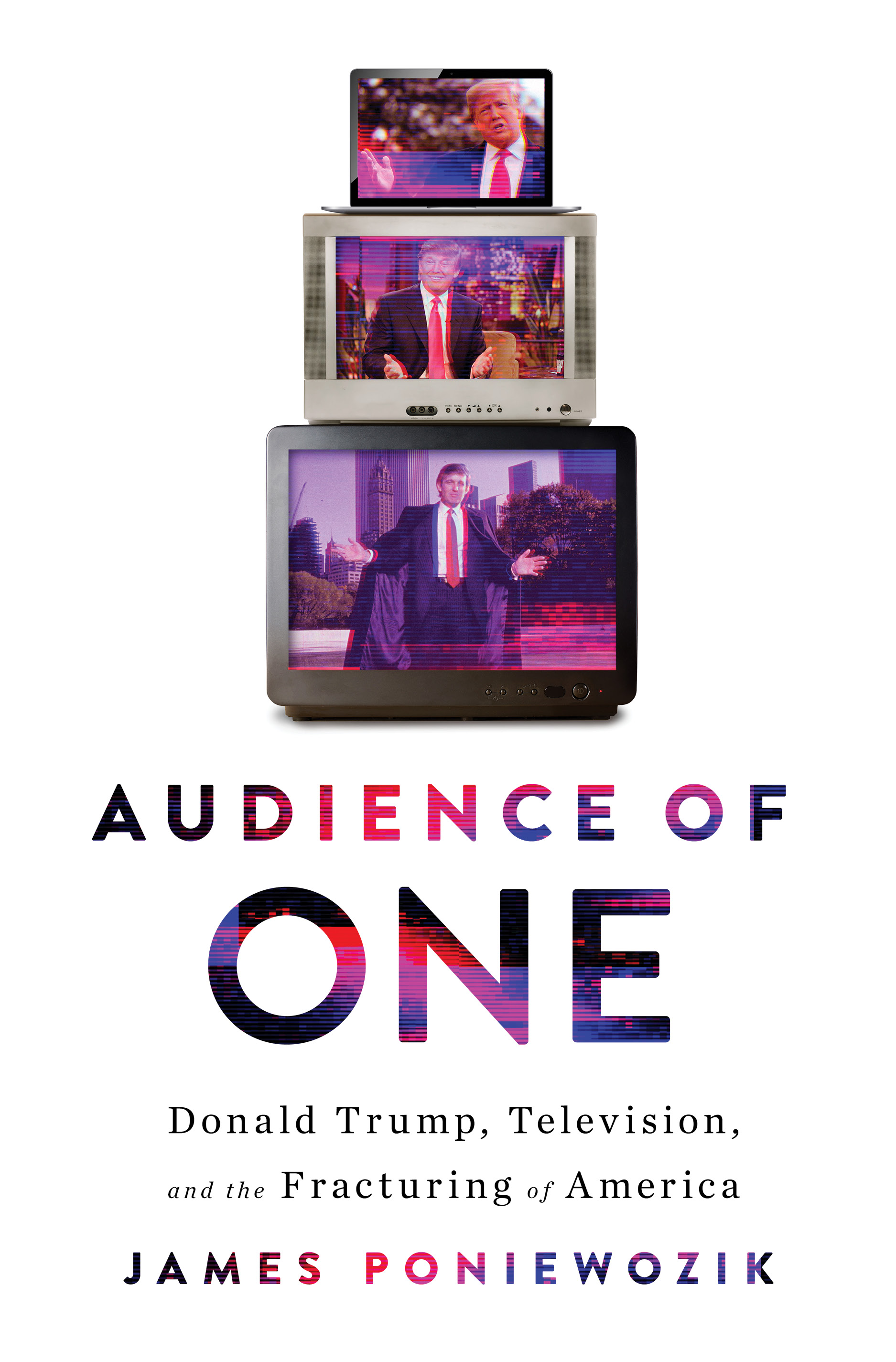
Audience of One New York Times Book Review • Notable Book of the Year Washington Post • 50 Notable Works of Nonfiction in 2019 Publishers Weekly • 10 Best Books of the Year An incisive cultural history that captures a fractious nation through the prism of television and the rattled mind of a celebrity president. Television has entertained America, television has ensorcelled America, and with the election of Donald J. Trump, television has conquered America. In Audience of One, New York Times chief television critic James Poniewozik traces the history of TV and mass media from the Reagan era to today, explaining how a volcanic, camera-hogging antihero merged with America’s most powerful medium to become our forty-fifth president. In the tradition of Neil Postman’s masterpiece Amusing Ourselves to Death, Audience of One shows how American media have shaped American society and politics, by interweaving two crucial stories. The first story follows the evolution of television from the three-network era of the 20th century, which joined millions of Americans in a shared monoculture, into today’s zillion-channel, Internet-atomized universe, which sliced and diced them into fractious, alienated subcultures. The second story is a cultural critique of Donald Trump, the chameleonic celebrity who courted fame, achieved a mind-meld with the media beast, and rode it to ultimate power. Braiding together these disparate threads, Poniewozik combines a cultural history of modern America with a revelatory portrait of the most public American who has ever lived. Reaching back to the 1940s, when Trump and commercial television were born, Poniewozik illustrates how Donald became “a character that wrote itself, a brand mascot that jumped off the cereal box and entered the world, a simulacrum that replaced the thing it represented.†Viscerally attuned to the media, Trump shape-shifted into a boastful tabloid playboy in the 1980s; a self-parodic sitcom fixture in the 1990s; a reality-TV “You’re Fired†machine in the 2000s; and finally, the biggest role of his career, a Fox News–obsessed, Twitter-mad, culture-warring demagogue in the White House. Poniewozik deconstructs the chaotic Age of Trump as the 24-hour TV production that it is, decoding an era when politics has become pop culture, and vice versa. Trenchant and often slyly hilarious, Audience of One is a penetrating and sobering review of the raucous, raging, farcical reality show—performed for the benefit of an insomniac, cable-news-junkie “audience of oneâ€â€”that we all came to live in, whether we liked it or not. POLITICAL SCIENCE,Political Process,Media & Internet

Becoming a Citizen Activist From post-inauguration rallies to #NoDAPL and the Black Lives Matter movement to the global Women’s March on Washington, the people are exercising their power through protest and community organizing in a way that hasn’t been seen in years. For those looking to organize for the first time or for seasoned activists looking to update their repertoire, the time is ripe for a playbook like Becoming a Citizen Activist. A longtime Seattle city councilmember and one of the city’s most effective and inspiring leaders of progressive political and social change since the 1960s, Nick Licata outlines how to get organized and master the tactics to create change by leveraging effective communication strategies (such as creating community through online channels like Facebook and Twitter), how to effectively engage traditional media channels, and how to congregate local and national people power. Licata demonstrates by example that we can fight city hall. Balancing an idealistic vision of a better world with the clear-eyed pragmatism necessary to build it from the ground up, this smart and powerful book will empower any activist with the tools they need to effect change. POLITICAL SCIENCE,Political Process,Political Advocacy
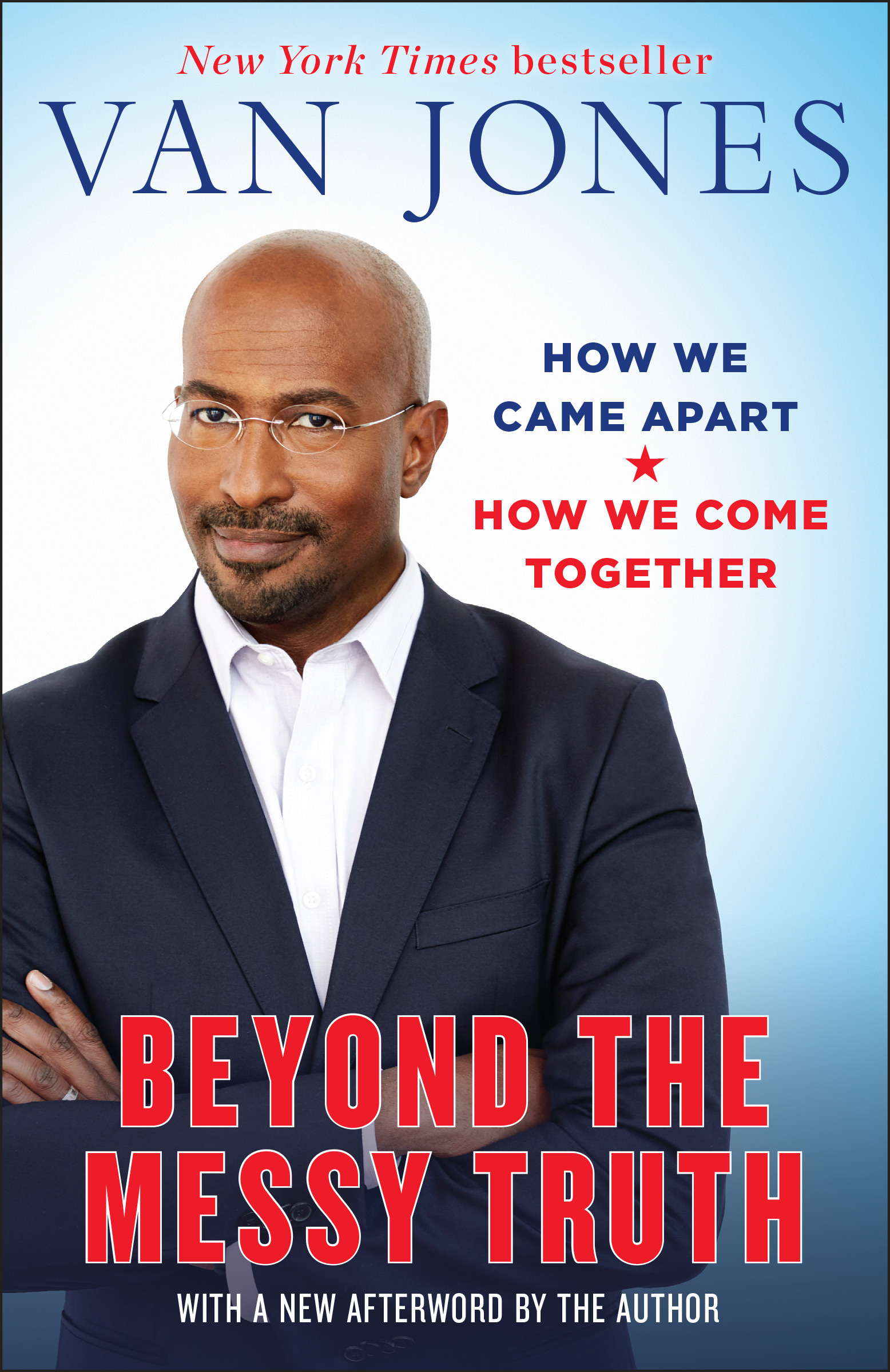
Beyond the Messy Truth NEW YORK TIMES BESTSELLER • A passionate manifesto that exposes hypocrisy on both sides of the political divide and points a way out of the tribalism that is tearing America apart—from the CNN host hailed as “a star of the 2016 campaign” (The New York Times), now seen on The Van Jones Show Van Jones burst into the American consciousness during the 2016 presidential campaign with an unscripted, truth-telling style and an already established history of bridge-building across party lines. His election night commentary, during which he coined the term “whitelash,” became a viral sensation. A longtime progressive activist with deep roots in the conservative South, Jones has made it his mission to challenge voters and viewers to stand in one another’s shoes and disagree constructively. In Beyond the Messy Truth, he offers a blueprint for transforming our collective anxiety into meaningful change. Jones urges both parties to abandon the politics of accusation. He issues a stirring call for a new “bipartisanship from below,” pointing us toward practical answers to problems that affect us all regardless of region or ideology. He wants to tackle rural and inner-city poverty, unemployment, addiction, unfair incarceration, and the devastating effects of the pollution-based economy on both coal country and our urban centers. Along the way, Jones shares memories from his decades of activism on behalf of working people, inspiring stories of ordinary citizens who became champions of their communities, and little-known examples of cooperation in the midst of partisan conflict. In his quest for positive solutions, Van Jones encourages us to set fire to our old ways of thinking about politics and come together to help those most in need. Includes an invaluable resource of contacts, books, media, and organizations for bipartisan bridge-building and problem solving. “Van Jones is a light in the darkness when we need it most. In the tradition of the great bridge builders of our past, Van’s love for this country and all its people shines through.”—Cory Booker, U.S. senator, New Jersey “Van Jones’s voice has become an integral part of our national political debate. He is one of the most provocative and interesting political figures in the country.”—Bernie Sanders, U.S. senator, Vermont POLITICAL SCIENCE,Political Process,Political Advocacy
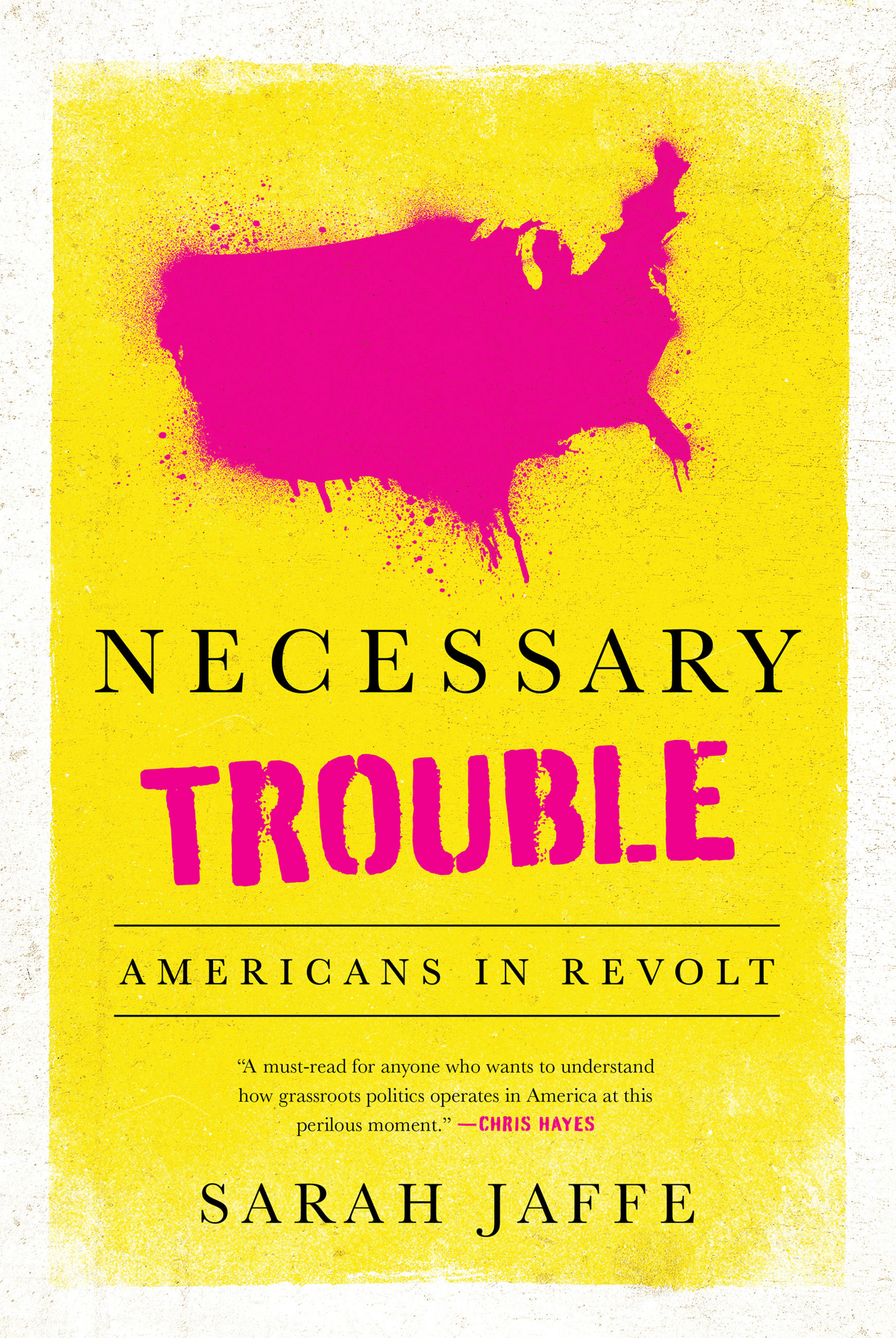
Necessary Trouble Necessary Trouble is the definitive book on the movements that are poised to permanently remake American politics. We are witnessing a moment of unprecedented political turmoil and social activism. Over the last few years, we've seen the growth of the Tea Party, a twenty-first-century black freedom struggle with BlackLivesMatter, Occupy Wall Street, and the grassroots networks supporting presidential candidates in defiance of the traditional party elites. Sarah Jaffe leads readers into the heart of these movements, explaining what has made ordinary Americans become activists. As Jaffe argues, the financial crisis in 2008 was the spark, the moment that crystallized that something was wrong. For years, Jaffe crisscrossed the country, asking people what they were angry about, and what they were doing to take power back. She attended a people's assembly in a church gymnasium in Ferguson, Missouri; walked a picket line at an Atlanta Burger King; rode a bus from New York to Ohio with student organizers; and went door-to-door in Queens days after Hurricane Sandy. From the successful fight for a 15 minimum wage in Seattle and New York to the halting of Shell's Arctic drilling program, Americans are discovering the effectiveness of making good, necessary trouble. Regardless of political alignment, they are boldly challenging who wields power in this country. POLITICAL SCIENCE,Political Process,Political Advocacy

Advocacy and Policy Change Evaluation This is the first book-length treatment of the concepts, designs, methods, and tools that are most useful in advocacy and policy change evaluation. Drawing on interdisciplinary literature, a large-scale survey, and case study research, it promises to be the definitive resource in the field. POLITICAL SCIENCE,Political Process,Political Advocacy

Together We Rise In celebration of the one-year anniversary of Women’s March, this gorgeously designed full-color book offers an unprecedented, front-row seat to one of the most galvanizing movements in American history, with exclusive interviews with Women’s March organizers, never-before-seen photographs, and essays by feminist activists. On January 21, 2017, the day after Donald J. Trump’s inauguration, more than three million marchers of all ages and walks of life took to the streets as part of the largest protest in American history. In red states and blue states, in small towns and major urban centers, from Boise to Boston, Bangkok to Buenos Aires, people from eighty-two countries—on all seven continents—rose up in solidarity to voice a common message: Hear our voice. It became the largest global protest in modern history. Compiled by Women’s March organizers, in partnership with Condé Nast and Glamour magazine Editor in Chief Cindi Leive, Together We Rise—published for the one-year anniversary of the event—is the complete chronicle of this remarkable uprising. For the first time, Women’s March organizers—including Bob Bland, Cassady Fendlay, Sarah Sophie Flicker, Janaye Ingram, Tamika Mallory, Paola Mendoza, Carmen Perez, and Linda Sarsour —tell their personal stories and reflect on their collective journey in an oral history written by Jamia Wilson, writer, activist and director of The Feminist Press. They provide an inside look at how the idea for the event originated, how it was organized, how it became a global movement that surpassed their wildest expectations, and how they are sustaining and building on the widespread outrage, passion, and determination that sparked it. Together We Rise interweaves their stories with "Voices from the March"—recollections from real women who were there, across the world—plus exclusive images by top photographers, and 20 short, thought-provoking essays by esteemed writers, celebrities and artists including Rowan Blanchard, Senator Tammy Duckworth, America Ferrera, Roxane Gay, Ilana Glazer, Ashley Judd, Valarie Kaur, David Remnick, Yara Shahidi, Jill Soloway, Jia Tolentino, Congresswoman Maxine Waters, and Elaine Welteroth. An inspirational call to action that reminds us that together, ordinary people can make a difference, Together We Rise is an unprecedented look at a day that made history—and the beginning of a resistance movement to reclaim our future. POLITICAL SCIENCE,Political Process,Political Advocacy
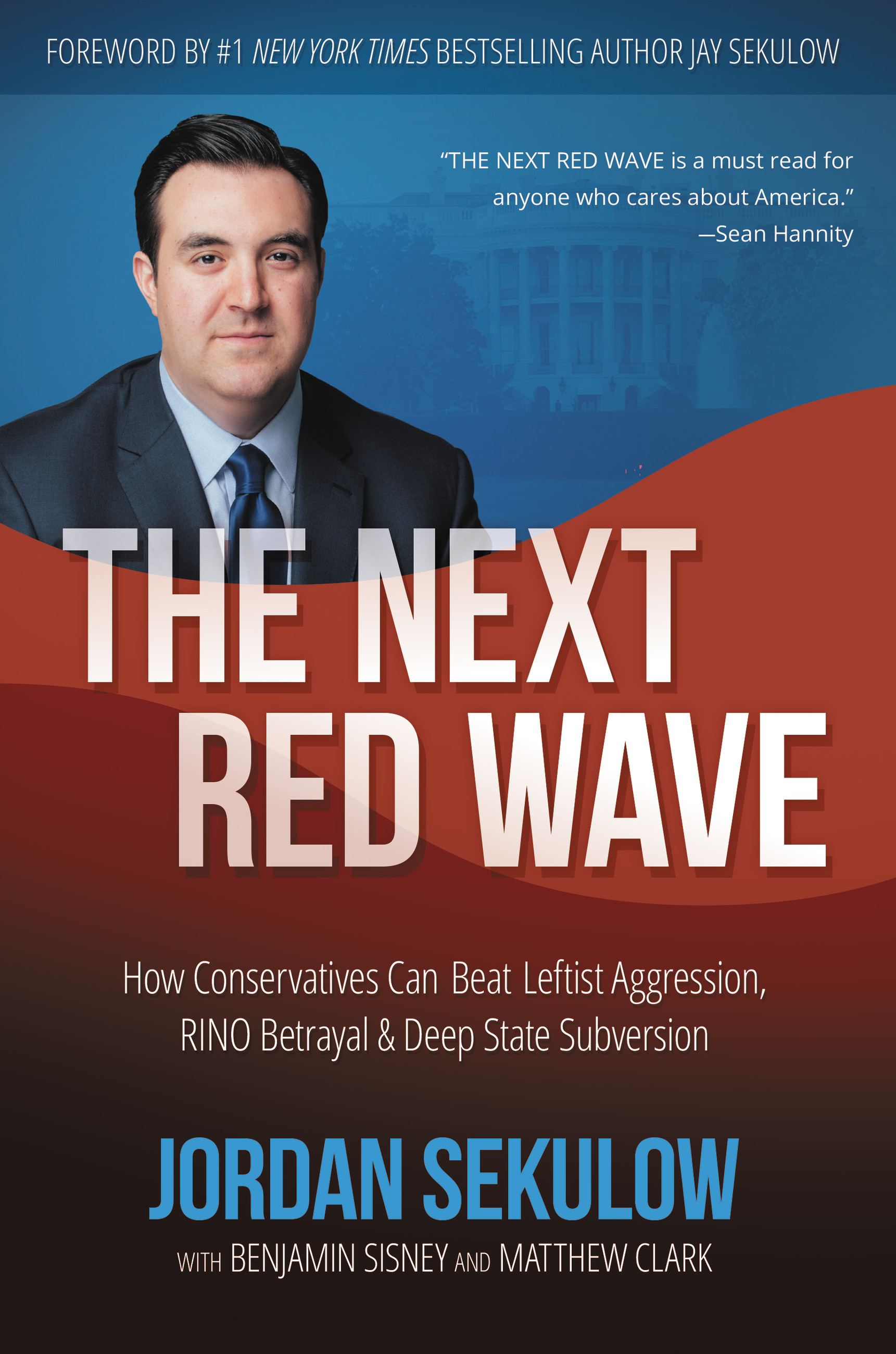
The Next Red Wave Popular radio host and conservative legal and political commentator Jordan Sekulow offers an action plan that will bring real change to government and help secure the future of our nation. The next red wave is coming: November 3, 2020. We face battles on many fronts. The Deep State bureaucracy will stop at nothing to undermine the conservative agenda, even when that's the agenda chosen by the American voter. The liberal bureaucracy will continue to work alongside former liberal government officials from, yes, the Obama Administration and Team Clinton. In this election, the Left's prized goal - exclusively - will be defeating President Donald Trump by whatever means necessary. A red wave that surpasses the turnout and figures of the historic 2016 election will be the only way to win. Our opponents won't be caught off guard by President Trump again. I promise you, the DNC and liberal activists organizations began working on plans to defeat President Trump in 2020 before he was even inaugurated in 2017. In fact, we have evidence of FBI officials attempting to undermine President Trump as he was preparing to take the Oath of Office. So-called "progressives" and the radical Left relentlessly force their liberal agenda on the American people. Even when Republican majorities control both houses of Congress, the deck can feel stacked against us. The confirmation hearings for Justice Kavanaugh are a good reminder about the chaos liberals can cause even when they are in the minority. Now, Democrats control the House of Representatives while Republicans maintain control of the U.S. Senate. We deserve better. All Americans deserve better. We deserve politicians who keep their promises. The only way to force action and hold our elected officials accountable is to know the issues and engage the political process. But it's more than just fulfilling our civic duty at the ballot box. It's being actively engaged in public discourse in between elections. Battles - important battles - are won far more often in the court of public opinion than in any federal courtroom. These battles affect our lives every single day. It's time to fight back and come together to generate the next red wave. We can't wait another moment. Now is the time to do it. It really is up to us. The clock is ticking. p.p1 {margin: 0.0px 0.0px 0.0px 0.0px; text-align: justify; font: 12.0px Geneva} p.p2 {margin: 0.0px 0.0px 0.0px 0.0px; text-align: justify; font: 12.0px Geneva; min-height: 16.0px} POLITICAL SCIENCE,Political Process,Political Advocacy
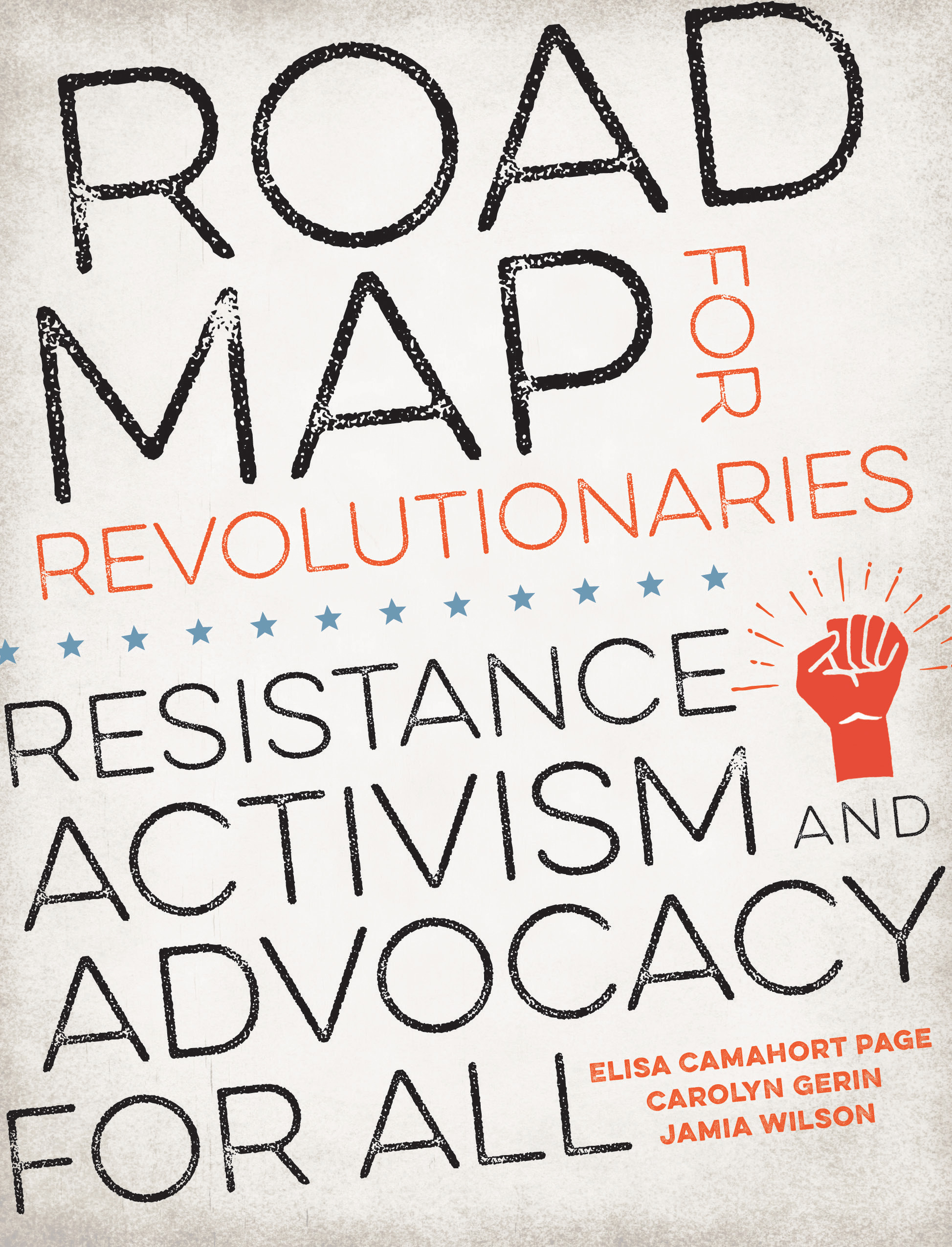
Road Map for Revolutionaries A handbook for effective activism, advocacy, and social justice for people of all ages and backgrounds. Are you ready to take action and make your voice heard, but don't know how to go about it? This hands-on, hit-the-ground-running guide delivers lessons on practical tactics for navigating and protecting one's personal democracy in a gridlocked, heavily surveilled, and politically volatile country. If you want to start making a difference but don’t know what to do next, Road Map for Revolutionaries provides the resources needed to help you feel safer, more empowered, invested in, and intrinsic to the American experiment. The book addresses timely topics such as staying safe at protests, supporting marginalized communities, online privacy, and how to keep up the fight for the long term, breaking down key issues and outlining action steps for local, state, and federal levels of government. POLITICAL SCIENCE,Political Process,Political Advocacy
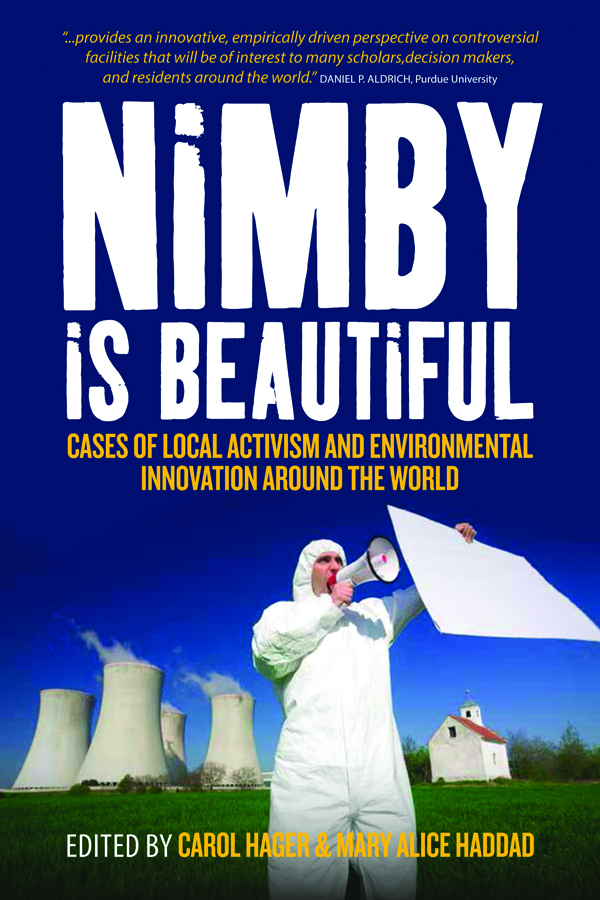
Nimby Is Beautiful NIMBY (Not In My Back Yard) protests are often criticized as parochial and short-lived, generating no lasting influence on broader processes related to environmental politics. This volume offers a different perspective. Drawing on cases from around the globe, it demonstrates that NIMBY protests, although always arising from a local concern in a particular community, often result in broader political, social, and technological change. Chapters include cases from Europe, North America, and Asia, engaging with the full political spectrum from established democracies to non-democratic countries. Regardless of political setting, NIMBY movements can have a positive and proactive role in generating innovative solutions to local as well as transnational environmental issues. Furthermore, those solutions are now serving as models for communities and countries around the world. POLITICAL SCIENCE,Political Process,Political Advocacy

Speaking Out in Vietnam Since 1990 public political criticism has evolved into a prominent feature of Vietnam's political landscape. So argues Benedict Kerkvliet in his analysis of Communist Party–ruled Vietnam. Speaking Out in Vietnam assesses the rise and diversity of these public displays of disagreement, showing that it has morphed from family whispers to large-scale use of electronic media. In discussing how such criticism has become widespread over the last three decades, Kerkvliet focuses on four clusters of critics: factory workers demanding better wages and living standards; villagers demonstrating and petitioning against corruption and land confiscations; citizens opposing China's encroachment into Vietnam and criticizing China-Vietnam relations; and dissidents objecting to the party-state regime and pressing for democratization. He finds that public political criticism ranges from lambasting corrupt authorities to condemning repression of bloggers to protesting about working conditions. Speaking Out in Vietnam shows that although we may think that the party-state represses public criticism, in fact Vietnamese authorities often tolerate and respond positively to such public and open protests. POLITICAL SCIENCE,Political Process,Political Advocacy
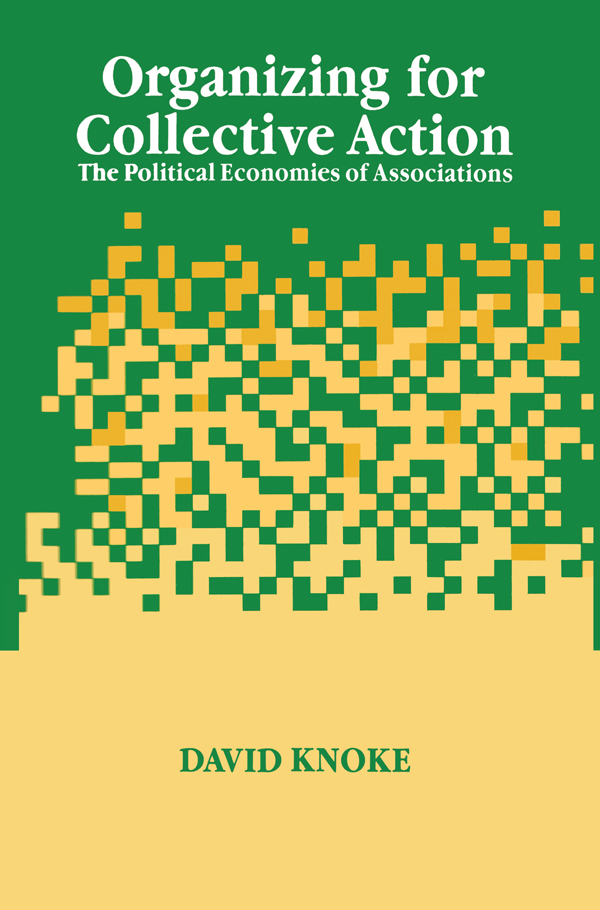
Organizing for Collective Action Organizing for Collective Action investigates the political and economic behaviors of national associations, including trade associations, professional societies, labor unions, and public interest groups. It focuses upon the ways that these organizations acquire resources and allocate them to various collective actions, particularly for member services, public relations, and political action. This analysis is structured around three broad theoretical paradigms for collective action: (1) the problem of societal integration which concerns the ways that people are tied to organizations and the ways that organizations connect their members with the larger society; (2) the problem of organizational governance which considers how individuals become unified collectivities capable of acting in a coordinated manner, and (3) the problem of public policy influence which involves interactions among public and private interest groups to formulate the binding decisions under which we all must live. POLITICAL SCIENCE,Political Process,Political Advocacy
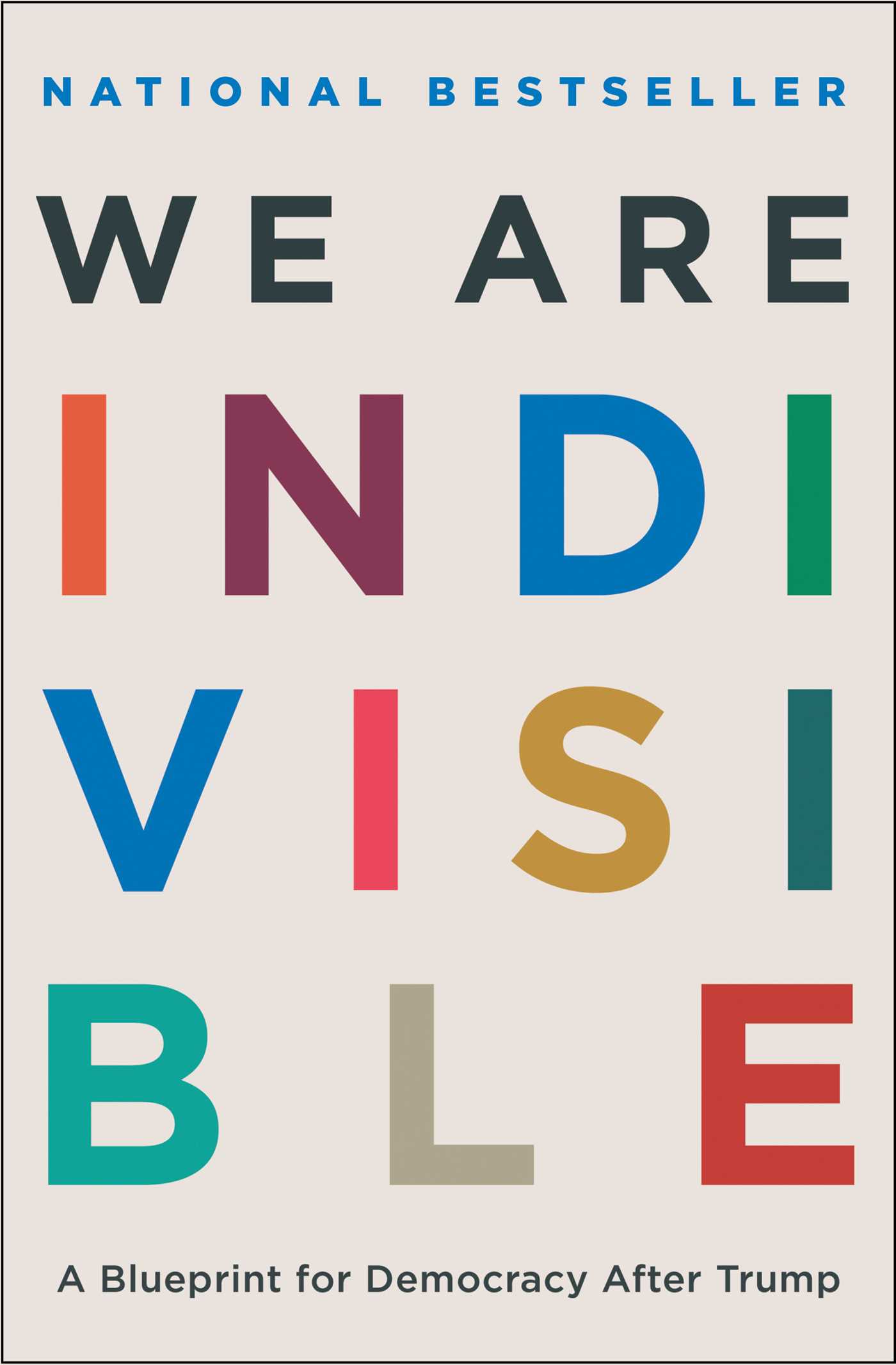
We Are Indivisible NATIONAL BESTSELLER “The breakout star of the new activists.†—The Economist “If Democrats are able to retake the House in 2018, it will be a victory built from Greenberg and Levin’s blueprint.†—Politico “One of the biggest successes so far this year...Indivisible has played a leading role in turning out voters at congressional town halls to voice their opposition.†—The New York Times “The centerpiece of a robust new grassroots machinery.†—Rolling Stone This is a story of democracy under threat. It’s the story of a movement rising up to respond. And it’s a story of what comes next. Shortly after Trump’s election, two outraged former congressional staffers wrote and posted a tactical guide to resisting the Trump agenda. This Google Doc entitled “Indivisible†was meant to be read by friends and family. No one could have predicted what happened next. It went viral, sparking the creation of thousands of local Indivisible groups in red, blue, and purple states, mobilizing millions of people and evolving into a defining movement of the Trump Era. From crowding town halls to killing TrumpCare to rallying around candidates to build the Blue Wave, Indivisibles powered the fight against Trump—and pushed the limits of what was politically possible. In We Are Indivisible: A Blueprint for Democracy After Trump, the (still-married!) co-executive directors of Indivisible tell the story of the movement. They offer a behind-the-scenes look at how change comes to Washington, whether Washington wants it or not. And they explain how we’ll win the coming fight for the future of American democracy. We Are Indivisible isn’t a book of platitudes about hope; it’s a steely-eyed guide to people power—how to find it, how to build it, and how to use it to usher in the post-Trump era. *All proceeds to the author go to Indivisible's Save Democracy Fund POLITICAL SCIENCE,Political Process,Political Advocacy
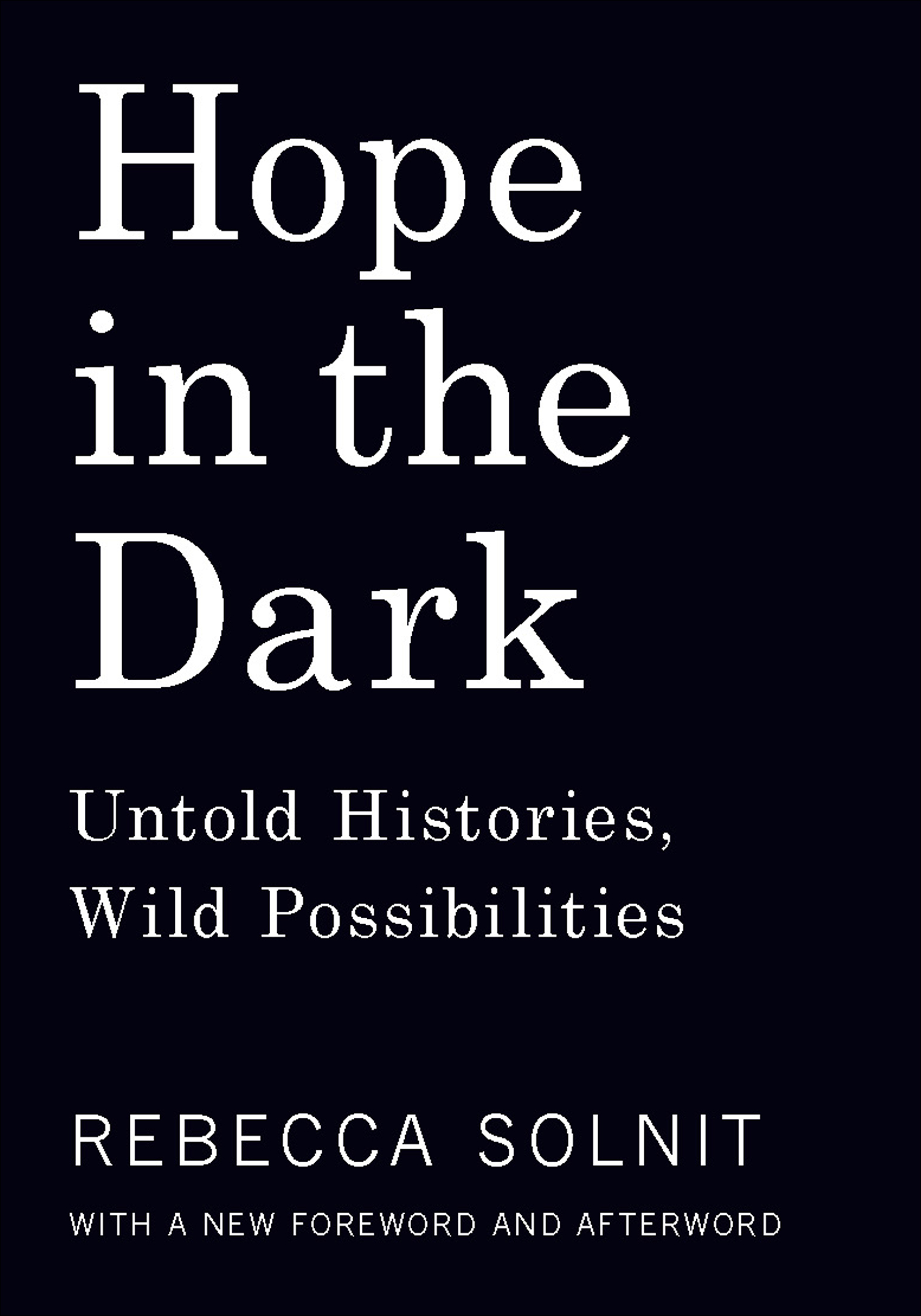
Hope in the Dark “[A] landmark book . . . Solnit illustrates how the uprisings that begin on the streets can upend the status quo and topple authoritarian regimes†(Vice). A book as powerful and influential as Rebecca Solnit’s Men Explain Things to Me, her Hope in the Dark was written to counter the despair of activists at a moment when they were focused on their losses and had turned their back to the victories behind them—and the unimaginable changes soon to come. In it, she makes a radical case for hope as a commitment to act in a world whose future remains uncertain and unknowable. Drawing on her decades of activism and a wide reading of environmental, cultural, and political history, Solnit argues that radicals have a long, neglected history of transformative victories, that the positive consequences of our acts are not always immediately seen, directly knowable, or even measurable, and that pessimism and despair rest on an unwarranted confidence about what is going to happen next. Now, with a moving new introduction explaining how the book came about and a new afterword that helps teach us how to hope and act in our unnerving world, she brings a new illumination to the darkness of our times in an unforgettable new edition of this classic book. “One of the best books of the 21st century.†—The Guardian “No writer has better understood the mix of fear and possibility, peril and exuberance that’s marked this new millennium.†—Bill McKibben, New York Times–bestselling author of Falter “An elegant reminder that activist victories are easily forgotten, and that they often come in extremely unexpected, roundabout ways.†—The New Yorker POLITICAL SCIENCE,Political Process,Political Advocacy

La guÃa de Bernie Sanders para la revolución polÃtica En este libro preciso y descarnado, Bernie Sanders, un polÃtico estadounidense de larga trayectoria progresista y senador independiente autodefinido como “socialista democrático," traza un diagnóstico de las calamidades sociales que afectan a Estados Unidos. Entre estas, Sanders delinea la creciente desigualdad de ingresos (el 1% más rico de los norteamericanos posee tanta riqueza como el 90% más pobre), la brutalidad policial, la inaccesibilidad a la educación superior, el racismo, los laberintos del sistema sanitario... Sanders deja enseñanzas para el resto del mundo: hay que transformar el sistema. POLITICAL SCIENCE,Political Process,Political Advocacy

Nights in Tents From an acclaimed musician comes an inside look at one of the most controversial and influential civil rights movements of our time. Nights in Tents is a memoir of the profoundly moving, and often hysterical, circumstances a fifty-one-year-old middle-class musician encountered when she abandoned a pleasantly predictable life on her pastoral, off-grid home nestled in the Cascade Mountains of Washington State to run off with the Occupy Movement. Internationally recognized singer/songwriter, Laura Love, put her music career on hold for a year to live in the chaotic tent encampments from Wall Street to Oakland. Traveling through the United States, Laura was immersed in the electrifying political culture of Occupy. She pitched her tent on city center concrete plazas; she helped shut down the Port of Oakland; she took over a Bank of America in San Francisco and was teargassed, arrested, and jailed for her trouble. All the while, she formed close bonds with the disparate characters who make up the 99 percent. Love’s insight into the importance of this moment in history, as well as her surprising predictions about the next phase, promise to inspire and enlighten. This lively, engaging account takes the reader on a journey that will captivate fans of political humor, women’s interests, African American perspectives, LGBT stories, as well as fans of narrative nonfiction and the memoir in general. Skyhorse Publishing, under our Night Shade and Talos imprints, is proud to publish a broad range of titles for readers interested in science fiction (space opera, time travel, hard SF, alien invasion, near-future dystopia), fantasy (grimdark, sword and sorcery, contemporary urban fantasy, steampunk, alternative history), and horror (zombies, vampires, and the occult and supernatural), and much more. While not every title we publish becomes a New York Times bestseller, a national bestseller, or a Hugo or Nebula award-winner, we are committed to publishing quality books from a diverse group of authors. POLITICAL SCIENCE,Political Process,Political Advocacy

Summary Execution “An incredible true story that reads like an international crime thriller.â€â€”Steve Jackson, New York Times bestselling author On June 1, 1981, two young activists, Silme Domingo and Gene Viernes, were murdered in Seattle in what was made to appear like a gang slaying. But the victims’ families and friends suspected they were considered a threat to the dictatorship of Philippines dictator Ferdinand Marcos and his regime’s relationship to the United States. In Summary Execution, attorney and author Michael Withey describes his ten-year battle for justice for Domingo and Viernes that he fought because “They killed my friends.†Follow along as he embarks on a long and dangerous investigation and into the courtroom to obtain convictions of three hitmen, and then prove in U.S. federal court that Marcos was behind the assassinations. If so, it would be the first time in U.S. history that a foreign head of state would be held liable for the murder of American citizens on U.S. soil. However, to accomplish this Withey and his legal team, working with the victims’ families and friends, would have to overcome numerous obstacles including exposing the perjured eyewitness testimony of an FBI informant, uncovering the brutal murder of an accomplice who was being sought to turn state’s evidence, and working around the failure by local authorities to prosecute the Marcos operative who planned the murders. “Remarkable . . . The story has so many twists—as well as amazing turns—that prove the point that conspiracy theories aren’t necessarily fiction.â€â€”Eric Nalder, Pulitzer Prize-winning investigative journalist POLITICAL SCIENCE,Political Process,Political Advocacy
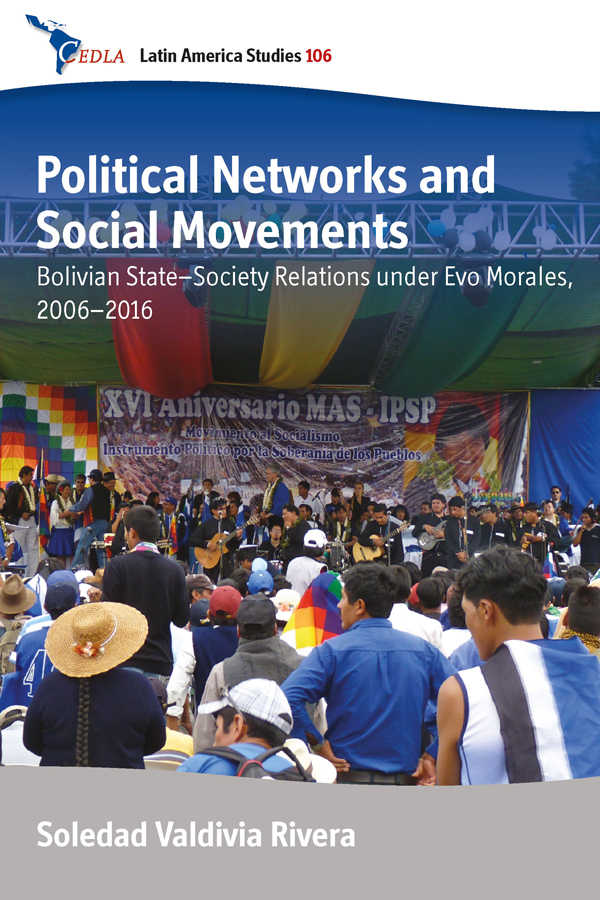
Political Networks and Social Movements After a landslide electoral victory in 2006, Evo Morales became the first indigenous President of Bolivia. Morales’s stunning ascent was mirrored by the rising fortunes of his political party, the leftist Movimiento al Socialismo, which today continues to challenge the status quo in Bolivian politics and implement ambitious social reforms. This study examines how the state and social movements have impacted democratization in Bolivia, along with other sectors such as NGOs and the media. Soledad Valdivia Rivera’s analysis helps us to understand how the movement's relationships have come to transform the Bolivian political process as we know it. POLITICAL SCIENCE,Political Process,Political Advocacy
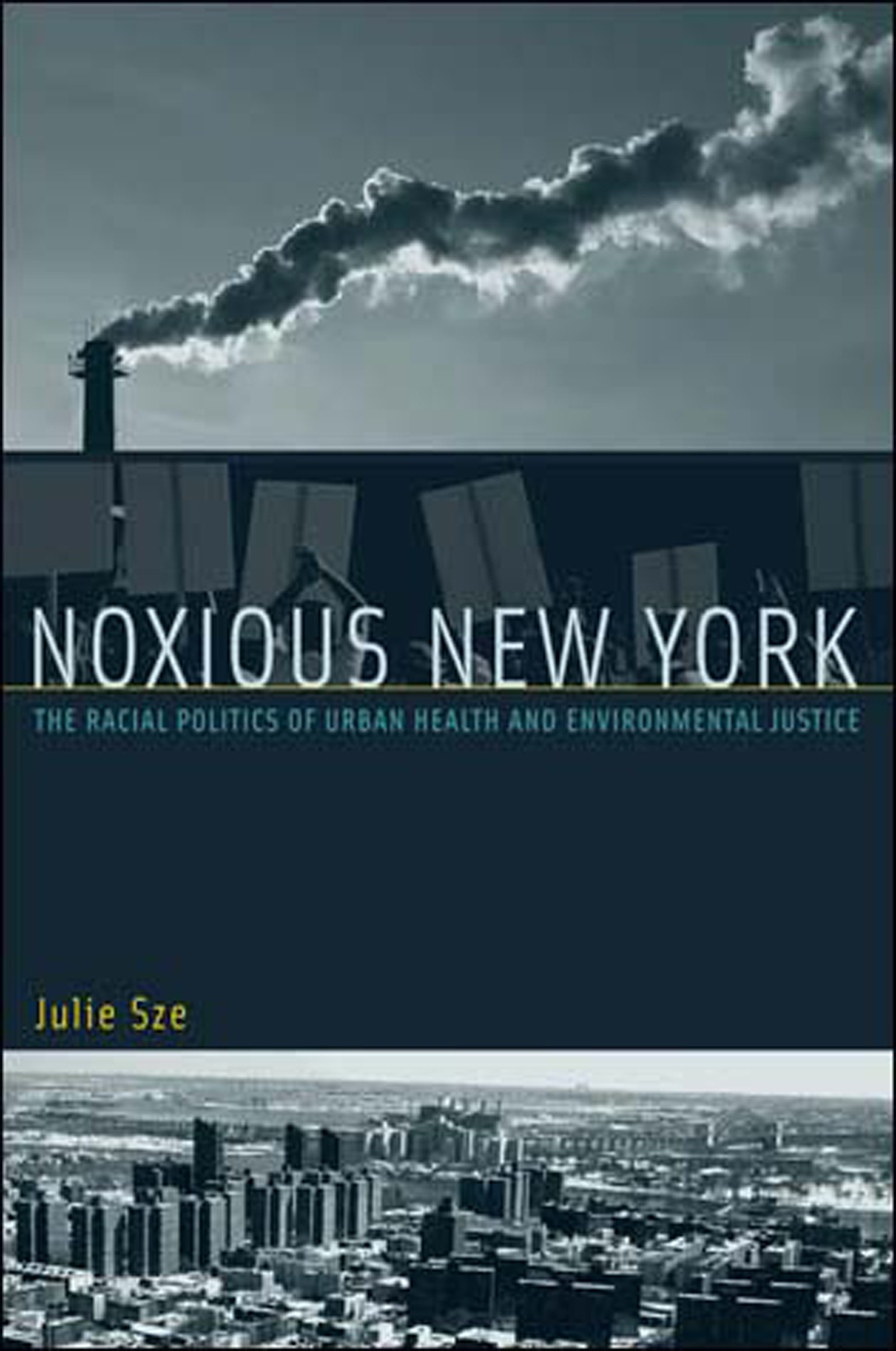
Noxious New York Examines the culture, politics, and history of the movement for environmental justice in New York City, tracking activism in four neighborhoods on issues of public health, garbage, and energy systems in the context of privatization, deregulation, and globalization. Racial minority and low-income communities often suffer disproportionate effects of urban environmental problems. Environmental justice advocates argue that these communities are on the front lines of environmental and health risks. In Noxious New York, Julie Sze analyzes the culture, politics, and history of environmental justice activism in New York City within the larger context of privatization, deregulation, and globalization. She tracks urban planning and environmental health activism in four gritty New York neighborhoods: Brooklyn's Sunset Park and Williamsburg sections, West Harlem, and the South Bronx. In these communities, activism flourished in the 1980s and 1990s in response to economic decay and a concentration of noxious incinerators, solid waste transfer stations, and power plants. Sze describes the emergence of local campaigns organized around issues of asthma, garbage, and energy systems, and how, in each neighborhood, activists framed their arguments in the vocabulary of environmental justice. Sze shows that the linkage of planning and public health in New York City goes back to the nineteenth century's sanitation movement, and she looks at the city's history of garbage, sewage, and sludge management. She analyzes the influence of race, family, and gender politics on asthma activism and examines community activists' responses to garbage privatization and energy deregulation. Finally, she looks at how activist groups have begun to shift from fighting particular siting and land use decisions to engaging in a larger process of community planning and community-based research projects. Drawing extensively on fieldwork and interviews with community members and activists, Sze illuminates the complex mix of local and global issues that fuels environmental justice activism. POLITICAL SCIENCE,Political Process,Political Advocacy

The Healthcare Fix A simple, straightforward, and foolproof proposal for universal health insurance from a noted economist. The shocking statistic is that forty-seven million Americans have no health insurance. When uninsured Americans go to the emergency room for treatment, however, they do receive care, and a bill. Many hospitals now require uninsured patients to put their treatment on a credit card which can saddle a low-income household with unpayably high balances that can lead to personal bankruptcy. Why don't these people just buy health insurance? Because the cost of coverage that doesn't come through an employer is more than many low- and middle-income households make in a year. Meanwhile, rising healthcare costs for employees are driving many businesses under. As for government-supplied health care, ever higher costs and added benefits (for example, Part D, Medicare's new prescription drug coverage) make both Medicare and Medicaid impossible to sustain fiscally; benefits grow faster than the national per-capita income. It's obvious the system is broken. What can we do? In The Healthcare Fix, economist Laurence Kotlikoff proposes a simple, straightforward approach to the problem that would create one system that works for everyone and secure America's fiscal and economic future. Kotlikoff's proposed Medical Security System is not the "socialized medicine" so feared by Republicans and libertarians; it's a plan for universal health insurance. Because everyone would be insured, it's also a plan for universal healthcare. Participants—including all who are currently uninsured, all Medicaid and Medicare recipients, and all with private or employer-supplied insurance—would receive annual vouchers for health insurance, the amount of which would be based on their current medical condition. Insurance companies would willingly accept people with health problems because their vouchers would be higher. And the government could control costs by establishing the values of the vouchers so that benefit growth no longer outstrips growth of the nation's per capita income. It's a "single-payer" plan, but a single payer for insurance. The American healthcare industry would remain competitive, innovative, strong, and private. Kotlikoff's plan is strong medicine for America's healthcare crisis, but brilliant in its simplicity. Its provisions can fit on a postcard and Kotlikoff provides one, ready to be copied and mailed to your representative in Congress. POLITICAL SCIENCE,Political Process,Political Advocacy
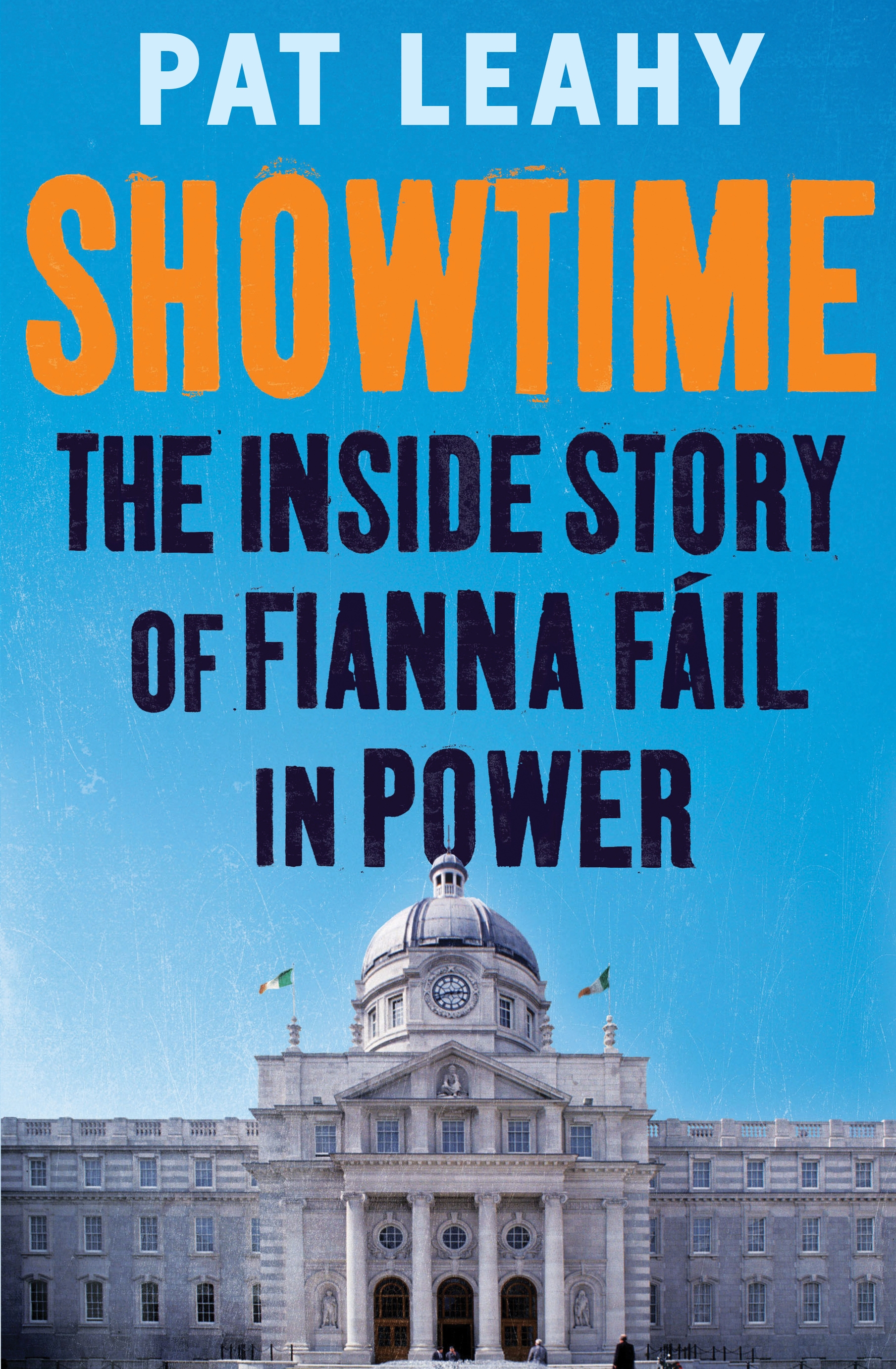
Showtime In boom and in bust, Ireland has been led by Fianna Fáil. Showtime gets behind the party's remarkable dominance of the political landscape and leading political writer Pat Leahy, tells the gripping story of how it won, kept and has used power since the mid-1990s. Showtime explains how Fianna Fáil operated during the boom years - from November 1994, when Bertie Ahern assumed leadership of a battered party, expecting to become Taoiseach but instead finding himself cast into opposition, to the day he relinquished the party leadership on the brink of the bust. For a decade after it achieved power in 1997, Fianna Fáil led the government during an unprecedented economic boom and enjoyed riches beyond the wildest dreams of any previous administration. Showtime reveals how government really worked in these years: the favours, the grudges, the backroom deals, the political strokes, the policy compromises and the choices that have led the country to where it is today. Showtime is politics in the raw: the exciting, enlightening and sometimes disturbing story of a remarkable era that changed the face of modern Ireland. POLITICAL SCIENCE,Political Process,Political Parties
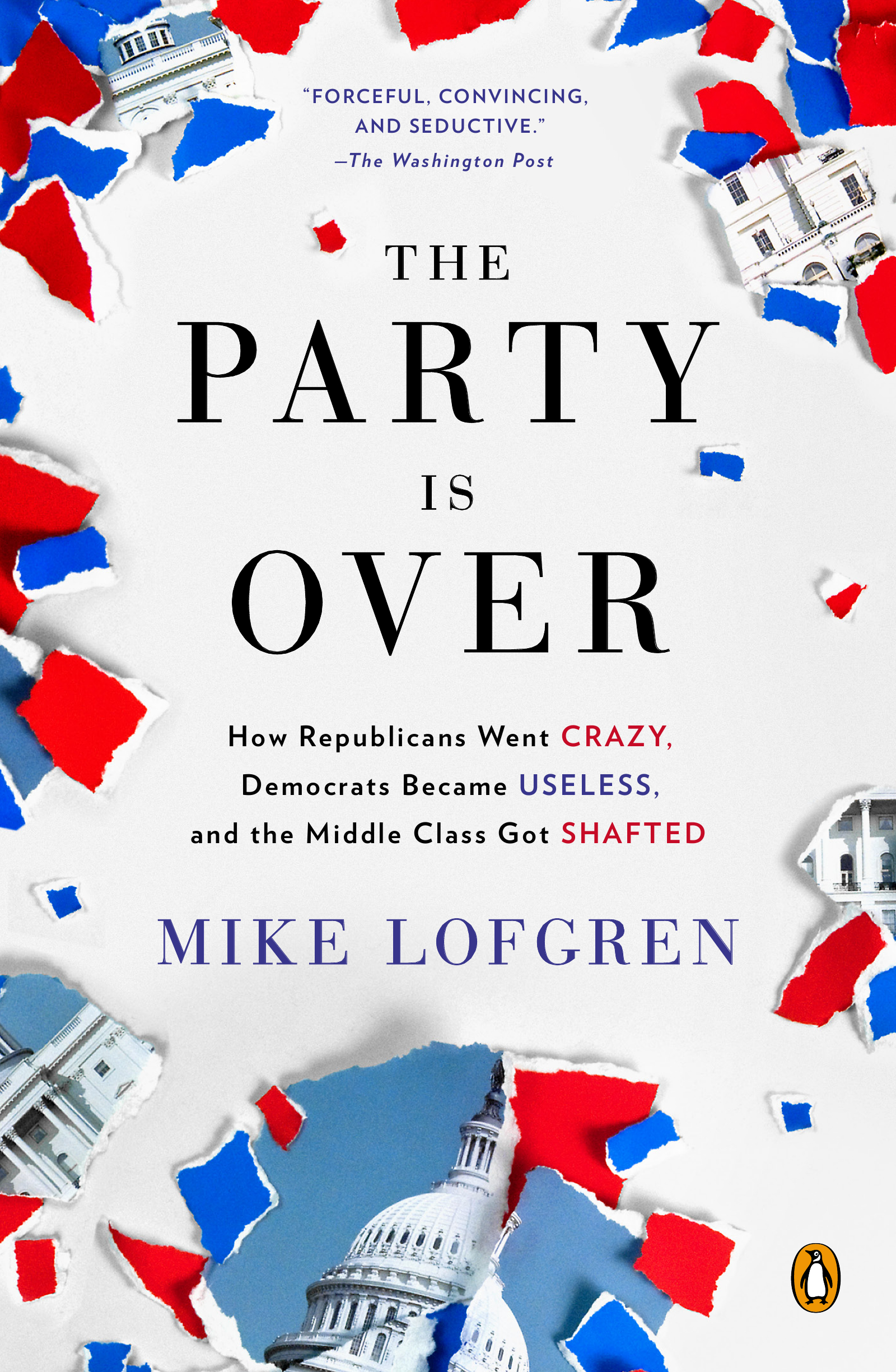
The Party Is Over The New York Times bestselling exposé of what passes for business as usual in Washington today There was a time, not so very long ago, when perfectly rational people ran the Republican Party. So how did the party of Lincoln become the party of lunatics? That is what this book aims to answer. Fear not, the Dems come in for their share of tough talk— they are zombies, a party of the living dead. Mike Lofgren came to Washington in the early eighties—those halcyon, post–Nixonian glory days—for what he imagined would be a short stint on Capitol Hill. He has witnessed quite a few low points in his twenty-eight years on the Hill—but none quite so pitiful as the antics of the current crop of legislators whom we appear to have elected. Based on the explosive article Lofgren wrote when he resigned in disgust after the debt ceiling crisis, The Party Is Over is a funny and impassioned exposé of everything that is wrong with Washington. Obama and his tired cohorts are no angels but they have nothing on the Republicans, whose wily strategists are bankrupting the country one craven vote at a time. Be prepared for some fireworks. POLITICAL SCIENCE,Political Process,Political Parties
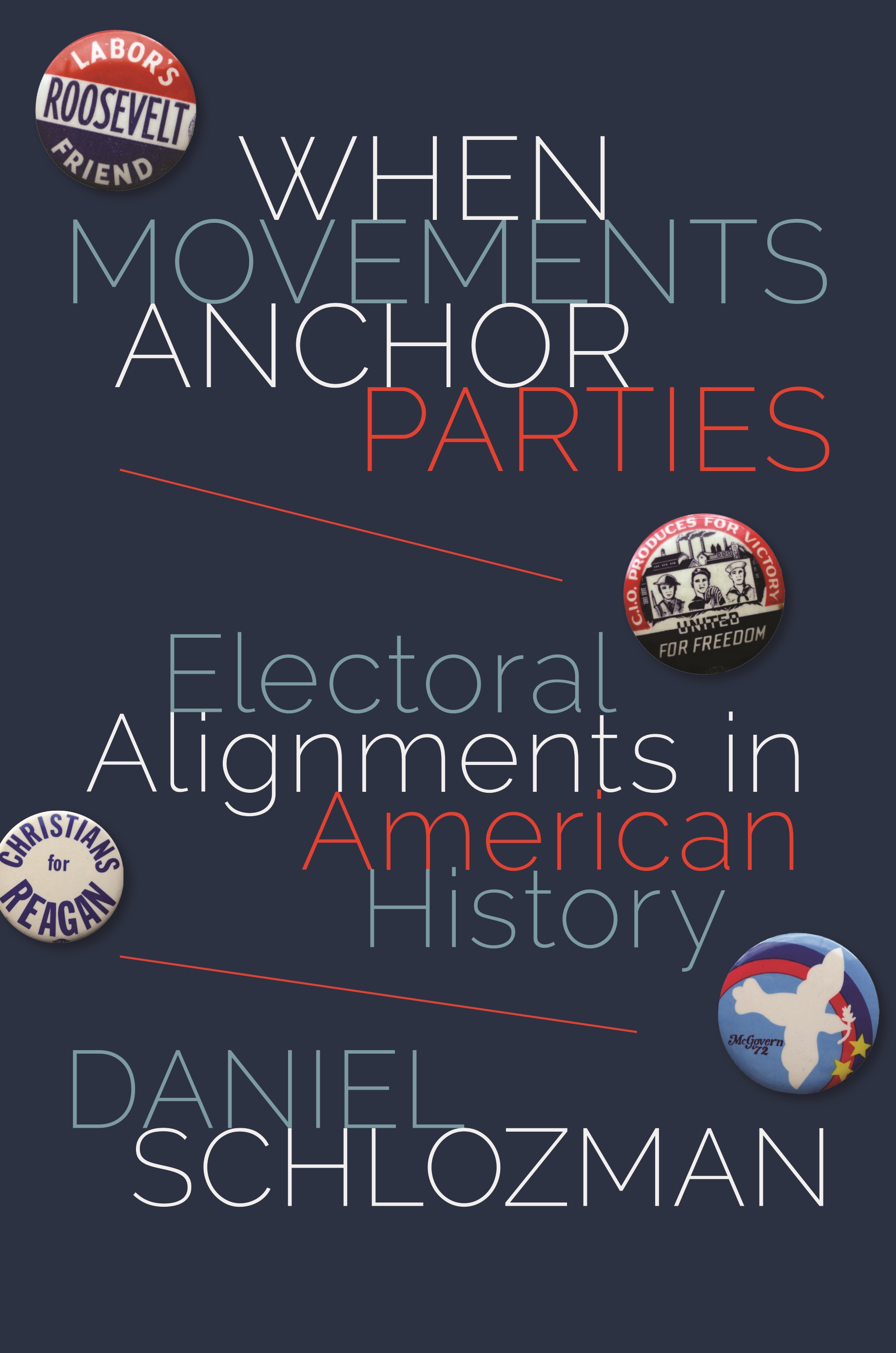
When Movements Anchor Parties Throughout American history, some social movements, such as organized labor and the Christian Right, have forged influential alliances with political parties, while others, such as the antiwar movement, have not. When Movements Anchor Parties provides a bold new interpretation of American electoral history by examining five prominent movements and their relationships with political parties. Taking readers from the Civil War to today, Daniel Schlozman shows how two powerful alliances—those of organized labor and Democrats in the New Deal, and the Christian Right and Republicans since the 1970s—have defined the basic priorities of parties and shaped the available alternatives in national politics. He traces how they diverged sharply from three other major social movements that failed to establish a place inside political parties—the abolitionists following the Civil War, the Populists in the 1890s, and the antiwar movement in the 1960s and 1970s. Moving beyond a view of political parties simply as collections of groups vying for preeminence, Schlozman explores how would-be influencers gain influence—or do not. He reveals how movements join with parties only when the alliance is beneficial to parties, and how alliance exacts a high price from movements. Their sweeping visions give way to compromise and partial victories. Yet as Schlozman demonstrates, it is well worth paying the price as movements reorient parties' priorities. Timely and compelling, When Movements Anchor Parties demonstrates how alliances have transformed American political parties. POLITICAL SCIENCE,Political Process,Political Parties

The Deep State The New York Times bestselling author of The Party Is Over delivers a no-holds-barred exposé of who really wields power in Washington Every Four years, tempers are tested and marriages fray as Americans head to the polls to cast their votes. But does anyone really care what we think? Has our vaunted political system become one big, expensive, painfully scriped reality TV show? In this cringe-inducing expose of the sins and excesses of Beltwayland, a longtime Republican party insider argues that we have become an oligarchy in form if not in name. Hooked on war, genuflecting to big donors, in thrall to discredited economic theories and utterly bereft of a moral compass, America’s governing classes are selling their souls to entrenched interest while our bridges collapse, wages, stagnate, and our water is increasingly undrinkable. Drawing on sinsights gleaned over three decades on Capitol Hill, much of it on the Budget Committee, Lofgren paints a gripping portrait of the dismal swamp on the Potomac and the revolution it will take to reclaim our government and set us back on course. POLITICAL SCIENCE,Political Process,Political Parties
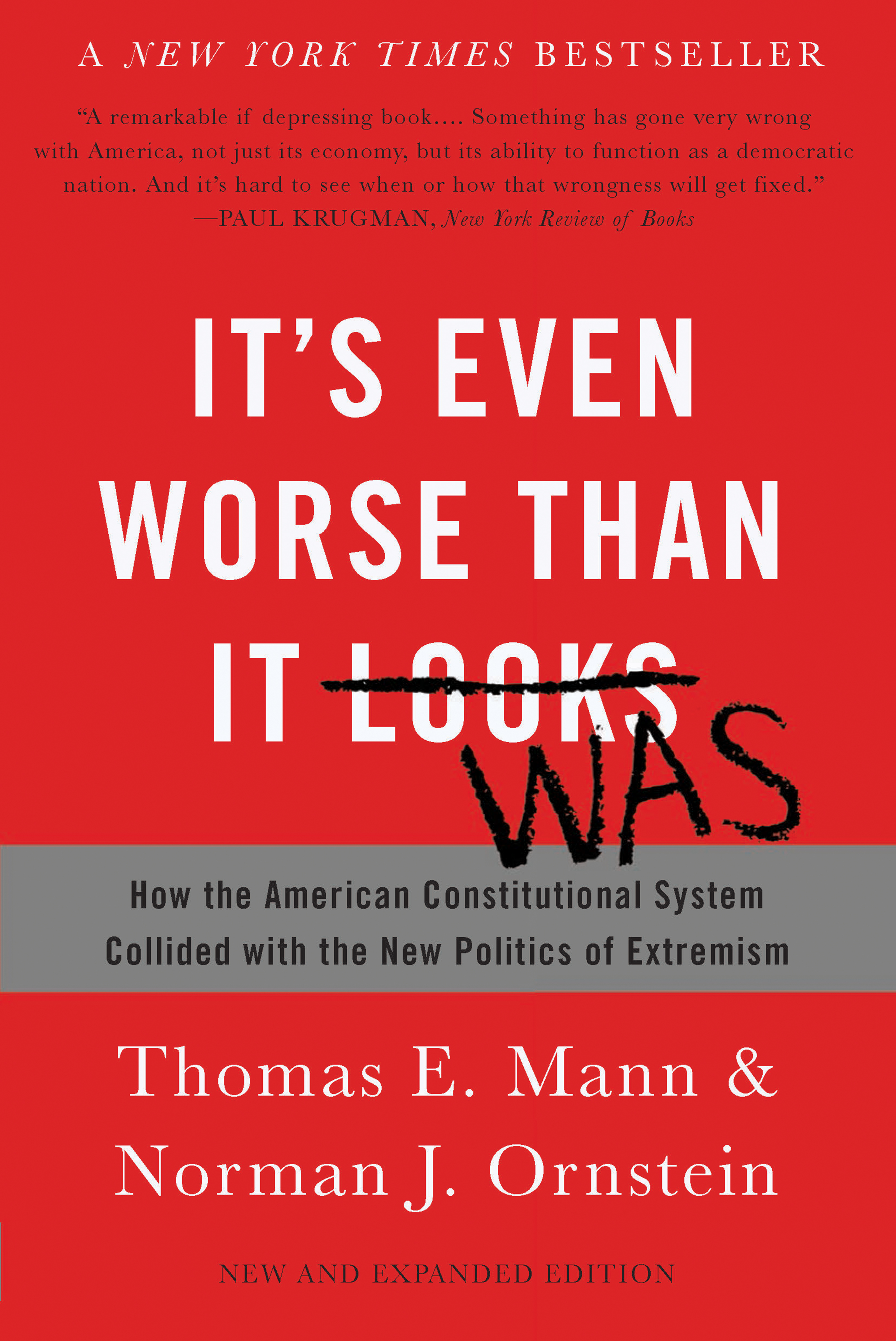
It's Even Worse Than It Looks Acrimony and hyperpartisanship have seeped into every part of the political process. Congress is deadlocked and its approval ratings are at record lows. America's two main political parties have given up their traditions of compromise, endangering our very system of constitutional democracy. And one of these parties has taken on the role of insurgent outlier; the Republicans have become ideologically extreme, scornful of compromise, and ardently opposed to the established social and economic policy regime.In It's Even Worse Than It Looks, congressional scholars Thomas Mann and Norman Ornstein identify two overriding problems that have led Congress -- and the United States -- to the brink of institutional collapse. The first is the serious mismatch between our political parties, which have become as vehemently adversarial as parliamentary parties, and a governing system that, unlike a parliamentary democracy, makes it extremely difficult for majorities to act. Second, while both parties participate in tribal warfare, both sides are not equally culpable. The political system faces what the authors call &"asymmetric polarization," with the Republican Party implacably refusing to allow anything that might help the Democrats politically, no matter the cost.With dysfunction rooted in long-term political trends, a coarsened political culture and a new partisan media, the authors conclude that there is no &"silver bullet"; reform that can solve everything. But they offer a panoply of useful ideas and reforms, endorsing some solutions, like greater public participation and institutional restructuring of the House and Senate, while debunking others, like independent or third-party candidates. Above all, they call on the media as well as the public at large to focus on the true causes of dysfunction rather than just throwing the bums out every election cycle. Until voters learn to act strategically to reward problem solving and punish obstruction, American democracy will remain in serious danger. POLITICAL SCIENCE,Political Process,Political Parties
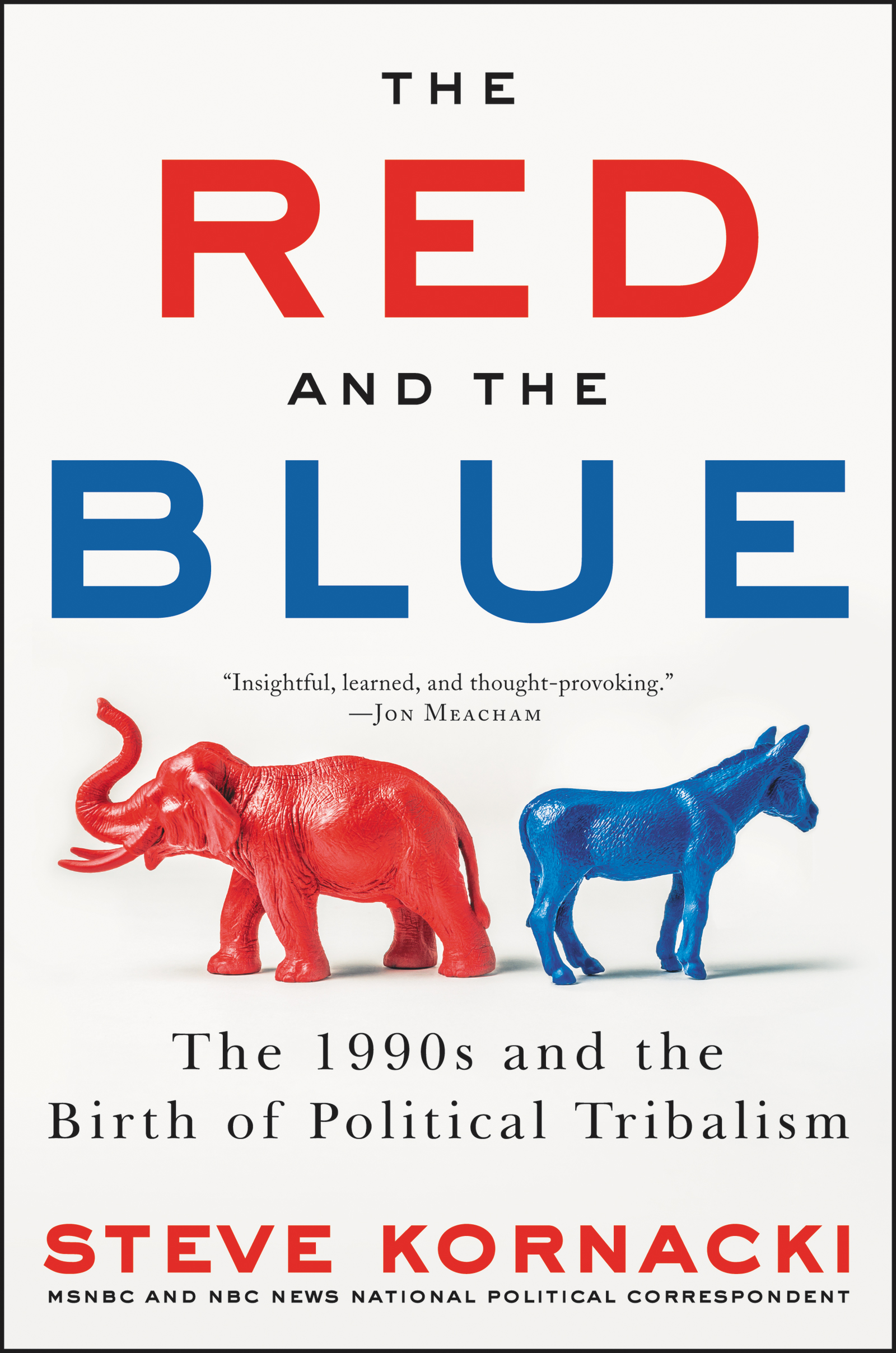
The Red and the Blue From MSNBC correspondent Steve Kornacki, a lively and sweeping history of the birth of political tribalism in the 1990s—one that brings critical new understanding to our current political landscape from Clinton to Trump In The Red and the Blue, cable news star and acclaimed journalist Steve Kornacki follows the twin paths of Bill Clinton and Newt Gingrich, two larger-than-life politicians who exploited the weakened structure of their respective parties to attain the highest offices. For Clinton, that meant contorting himself around the various factions of the Democratic party to win the presidency. Gingrich employed a scorched-earth strategy to upend the permanent Republican minority in the House, making him Speaker. The Clinton/Gingrich battles were bare-knuckled brawls that brought about massive policy shifts and high-stakes showdowns—their collisions had far-reaching political consequences. But the ’90s were not just about them. Kornacki writes about Mario Cuomo’s stubborn presence around Clinton’s 1992 campaign; Hillary Clinton’s star turn during the 1998 midterms, seeding the idea for her own candidacy; Ross Perot’s wild run in 1992 that inspired him to launch the Reform Party, giving Donald Trump his first taste of electoral politics in 1999; and many others. With novelistic prose and a clear sense of history, Steve Kornacki masterfully weaves together the various elements of this rambunctious and hugely impactful era in American history, whose effects set the stage for our current political landscape. POLITICAL SCIENCE,Political Process,Political Parties
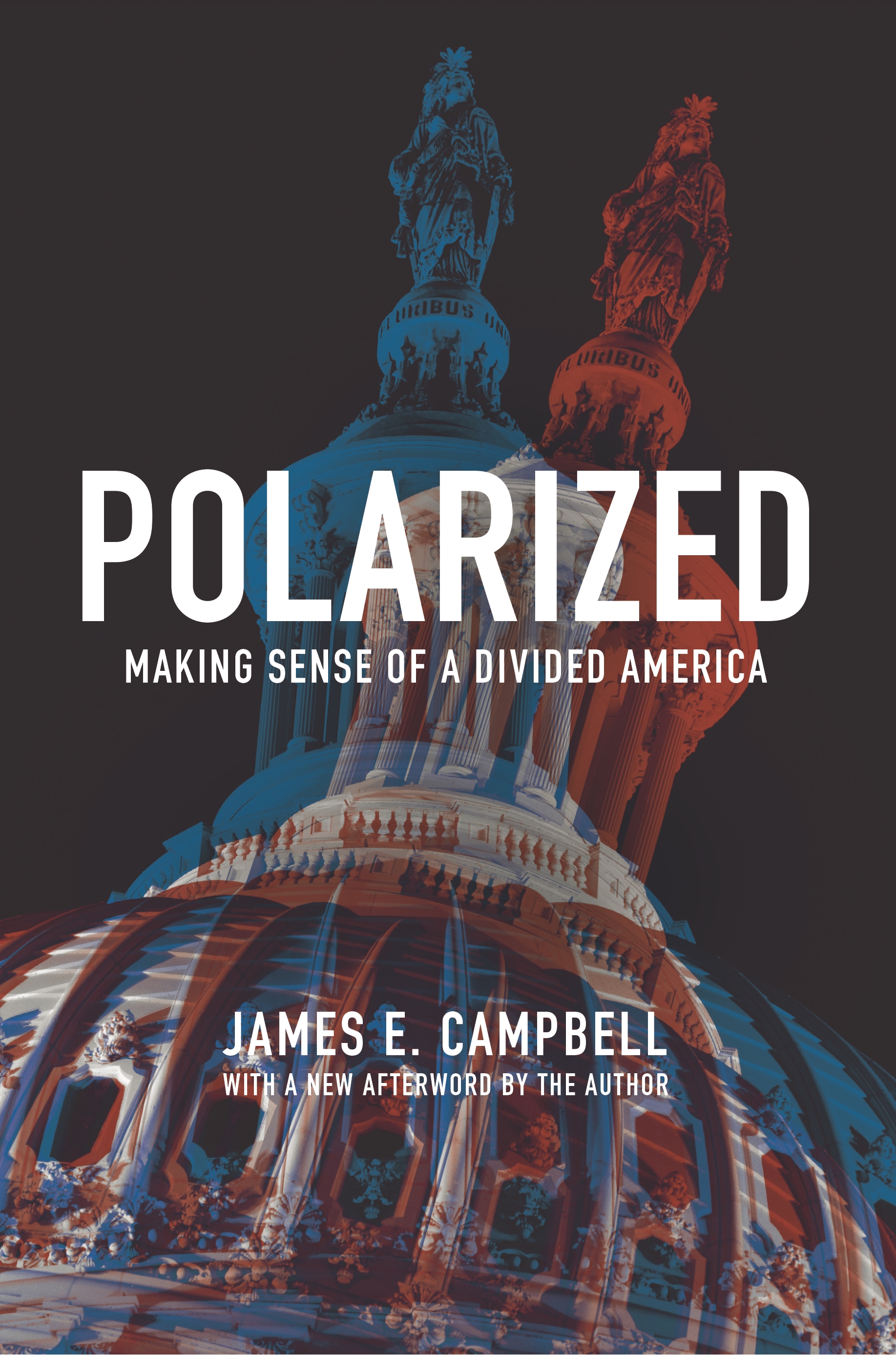
Polarized An eye-opening look at how and why America has become so politically polarized Many continue to believe that the United States is a nation of political moderates. In fact, it is a nation divided. It has been so for some time and has grown more so. This book provides a new and historically grounded perspective on the polarization of America, systematically documenting how and why it happened. Polarized presents commonsense benchmarks to measure polarization, draws data from a wide range of historical sources, and carefully assesses the quality of the evidence. Through an innovative and insightful use of circumstantial evidence, it provides a much-needed reality check to claims about polarization. This rigorous yet engaging and accessible book examines how polarization displaced pluralism and how this affected American democracy and civil society. Polarized challenges the widely held belief that polarization is the product of party and media elites, revealing instead how the American public in the 1960s set in motion the increase of polarization. American politics became highly polarized from the bottom up, not the top down, and this began much earlier than often thought. The Democrats and the Republicans are now ideologically distant from each other and about equally distant from the political center. Polarized also explains why the parties are polarized at all, despite their battle for the decisive median voter. No subject is more central to understanding American politics than political polarization, and no other book offers a more in-depth and comprehensive analysis of the subject than this one. POLITICAL SCIENCE,Political Process,Political Parties
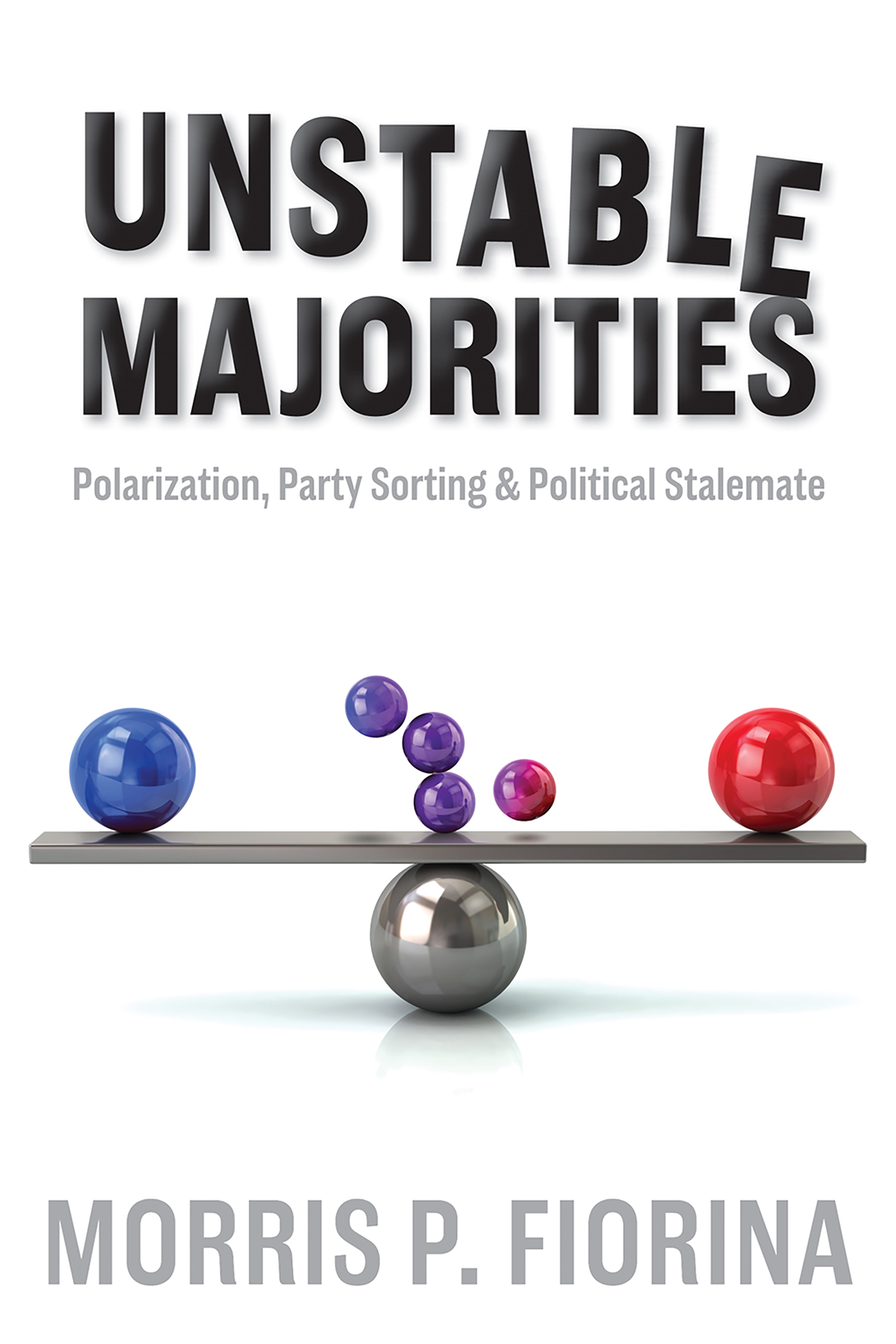
Unstable Majorities America is "currently fighting its second Civil War." Partisan politics are "ripping this country apart." The 2016 election "will go down as the most acrimonious presidential campaign of all." Such statements have become standard fare in American politics. In a time marked by gridlock and incivility, it seems the only thing Americans can agree on is this: we're more divided today than we've ever been in our history. In Unstable Majorities Morris P. Fiorina surveys American political history to reveal that, in fact, the American public is not experiencing a period of unprecedented polarization. Bypassing the alarmism that defines contemporary punditry, he cites research and historical context that illuminate the forces that shape voting patterns, political parties, and voter behavior. By placing contemporary events in their proper context, he corrects widespread misconceptions and gives reasons to be optimistic about the future of American electoral politics. POLITICAL SCIENCE,Political Process,Political Parties
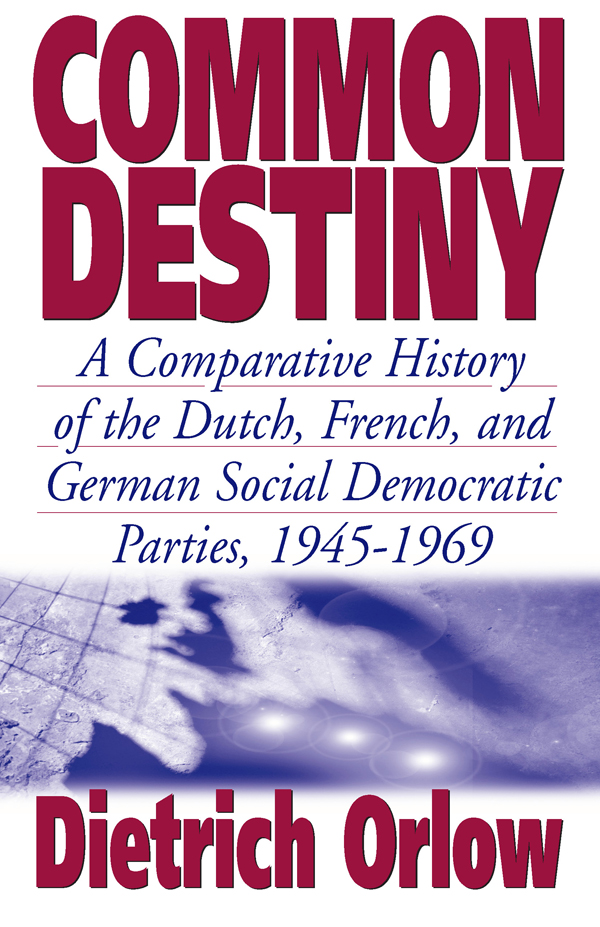
Common Destiny Although the Socialist or Social Democractic parties played a key role in West European politics during the quarter century after the Second World War, they have been studied far less than their political rivals, the Christian Democrats. The story of West European Social Democracy after 1945 begins with a dilemma: Democratic marxism, which had been the parties' ideological and organizational principle until the Second World War, was becoming politically irrelevant. The three parties analyzed here represent the spectrum of reactions among Social Democratic parties to this realization. The debate over the parties' programs and ideologies did not, of course, take place in a vacuum: the author devotes considerable space to a comparative analysis of the parties' leaders and organizational structures as well as the evolution of Social Democratic domestic and foreign policies. Immensely readable, this book not only offers an in-depth analysis of the postwar period crucial for the history of Social Democracy but also, because of its cross-national treatment of these three major parties, adds significantly to our understanding of the processes of European integration and the evolution of the Atlantic Alliance. POLITICAL SCIENCE,Political Process,Political Parties
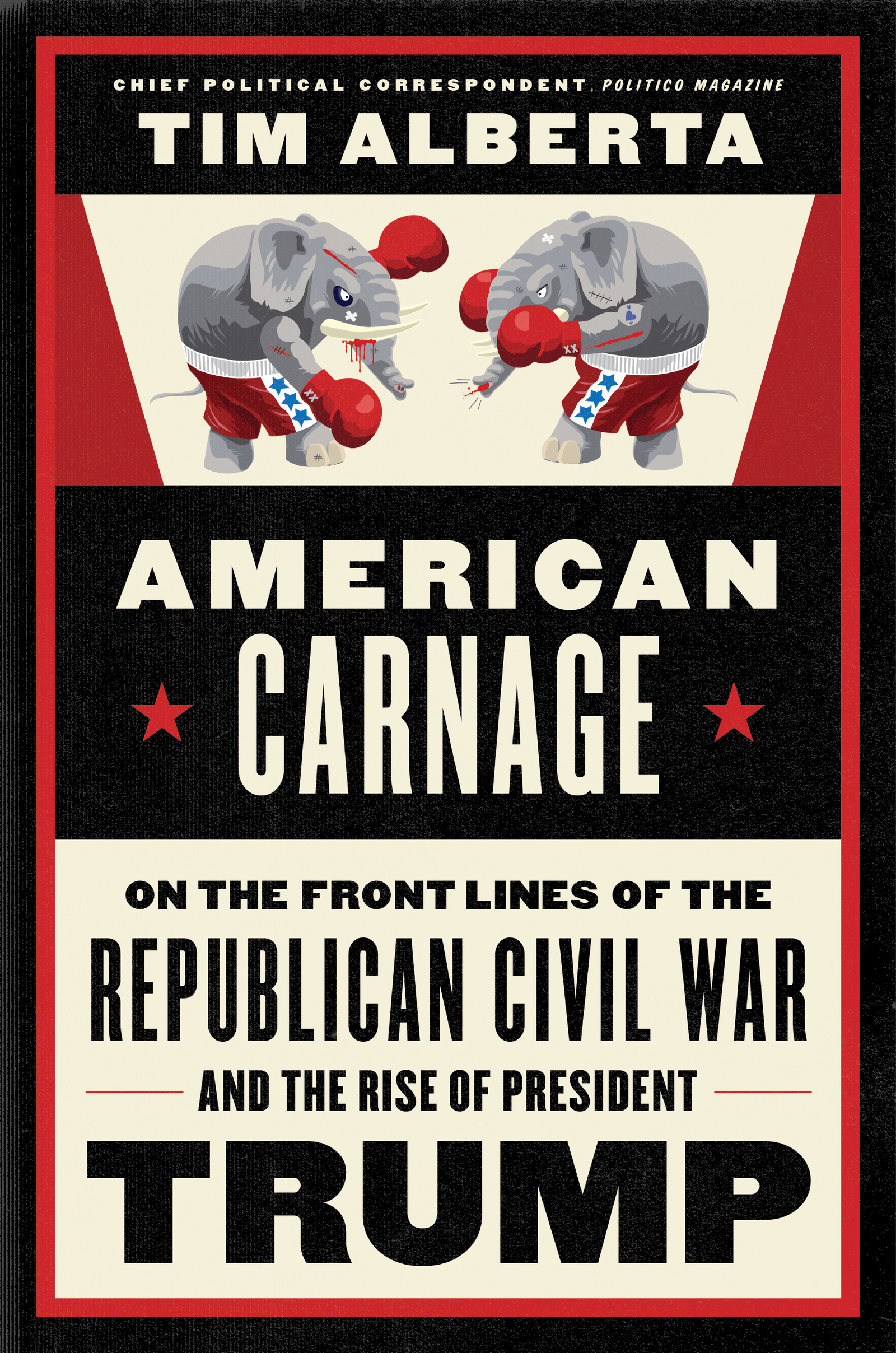
American Carnage New York Times' Top Books of 2019 Politico Magazine’s chief political correspondent provides a rollicking insider’s look at the making of the modern Republican Party—how a decade of cultural upheaval, populist outrage, and ideological warfare made the GOP vulnerable to a hostile takeover from the unlikeliest of insurgents: Donald J. Trump. The 2016 election was a watershed for the United States. But, as Tim Alberta explains in American Carnage, to understand Trump’s victory is to view him not as the creator of this era of polarization and bruising partisanship, but rather as its most manifest consequence. American Carnage is the story of a president’s rise based on a country’s evolution and a party’s collapse. As George W. Bush left office with record-low approval ratings and Barack Obama led a Democratic takeover of Washington, Republicans faced a moment of reckoning: They had no vision, no generation of new leaders, and no energy in the party’s base. Yet Obama’s forceful pursuit of his progressive agenda, coupled with the nation’s rapidly changing cultural and demographic landscape, lit a fire under the right, returning Republicans to power and inviting a bloody struggle for the party’s identity in the post-Bush era. The factions that emerged—one led by absolutists like Jim Jordan and Ted Cruz, the other led by pragmatists like John Boehner and Mitch McConnell—engaged in a series of devastating internecine clashes and attempted coups for control. With the GOP’s internal fissures rendering it legislatively impotent, and that impotence fueling a growing resentment toward the political class and its institutions, the stage was set for an outsider to crash the party. When Trump descended a gilded escalator to announce his run in the summer of 2015, the candidate had met the moment. Only by viewing Trump as the culmination of a decade-long civil war inside the Republican Party—and of the parallel sense of cultural, socioeconomic, and technological disruption during that period—can we appreciate how he won the White House and consider the fundamental questions at the center of America’s current turmoil. How did a party obsessed with the national debt vote for trillion-dollar deficits and record-setting spending increases? How did the party of compassionate conservatism become the party of Muslim bans and walls? How did the party of family values elect a thrice-divorced philanderer? And, most important, how long can such a party survive? Loaded with exclusive reporting and based off hundreds of interviews—including with key players such as President Trump, Paul Ryan, Ted Cruz, John Boehner, Mitch McConnell, Jim DeMint, and Reince Priebus, and many others—American Carnage takes us behind the scenes of this tumultuous period as we’ve never seen it before and establishes Tim Alberta as the premier chronicler of this political era. POLITICAL SCIENCE,Political Process,Political Parties
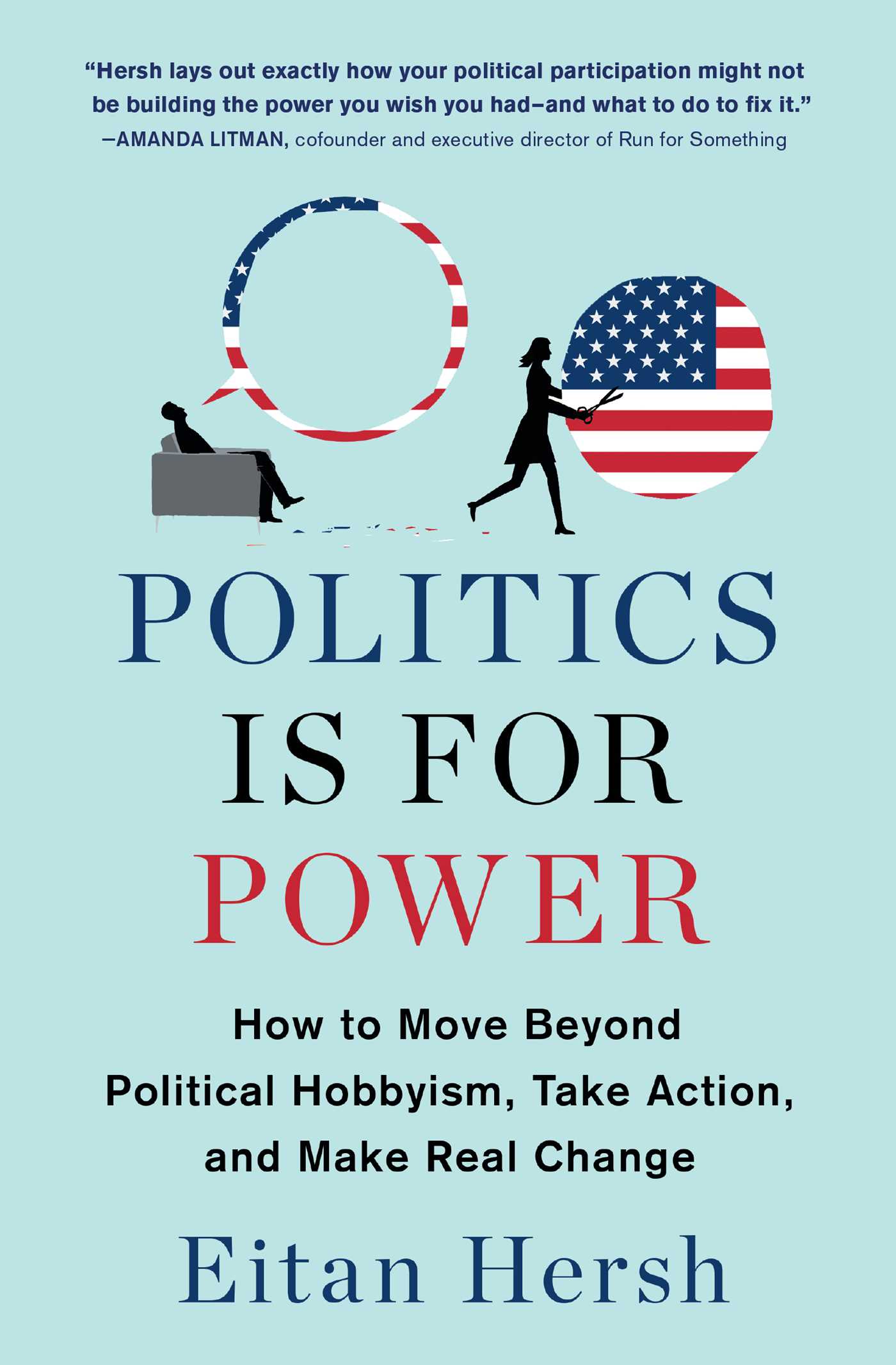
Politics Is for Power A groundbreaking analysis of political hobbyism—treating politics like a spectator sport—and an urgent and timely call to arms for the many well-meaning, well-informed citizens who follow political news, but do not take political action. Do you consider yourself politically engaged? Probably, yes! But are you, really? The uncomfortable truth is that most of us have good intentions. We vote (sometimes) and occasionally sign a petition or attend a rally. But we mainly “engage†by consuming politics as if it’s entertainment or a hobby. We obsessively follow the news and complain about the opposition to our friends or spouse. We tweet and post and share. The hours we spend on politics are used mainly as pastime. Instead, political scientist and data analyst Eitan Hersh offers convincing evidence that we should be spending the same number of hours building political organizations, implementing a long-term vision for our local communities, and getting to know our neighbors, whose votes will be needed for solving hard problems. We could be accumulating power so that when there are opportunities to make a difference—to lobby, to advocate, to mobilize—we will be ready. Aided by cutting-edge social science as well as remarkable stories of ordinary citizens who got off their couches and took political power seriously, this book shows us how to channel our energy away from political hobbyism and toward empowering our values. In an age of political turmoil and as the 2020 election looms, Politics Is for Power is an inspiring, vital read that will make you hopeful for America’s democratic future. POLITICAL SCIENCE,Political Process,Political Parties
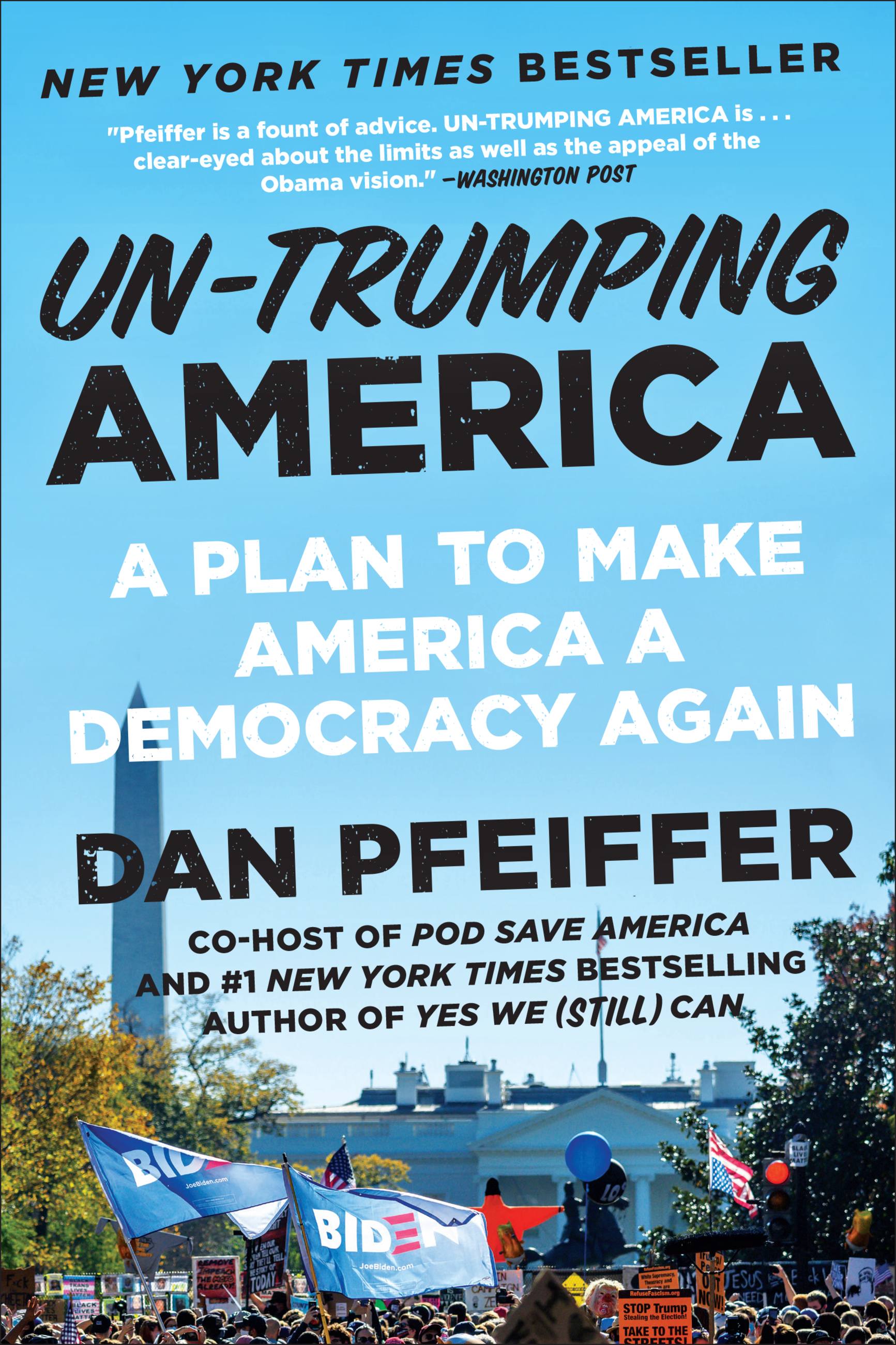
Un-Trumping America AN INSTANT NEW YORK TIMES BESTSELLER! From the #1 New York Times bestselling author of Yes We (Still) Can and cohost of Pod Save America, a sharp political playbook for how Democrats can take on Trump, McConnell, Fox News, and the rest of the right-wing circus dominating American politics. p.p1 {margin: 0.0px 0.0px 0.0px 0.0px; text-align: justify; font: 12.0px Arial; color: #232323} There is nothing more important than beating Donald Trump in 2020, but defeating Trump is just the start of this timely book. Un-Trumping America offers readers three critical insights: first, Trump is not an aberration, but rather the logical extension of the modern Republican Party; second, how Democrats can defeat Trump in 2020; and third, preventing the likes of Trump from ever happening again with a plan to fix democracy. While the catalog of the president's crimes is long and growing, undoing Trumpism -- the political platform of racism, authoritarianism, and plutocracy that gave rise to Trump and defines the Republican Party -- is a long and continuing fight. Through a craven, cynical strategy engineered by Mitch McConnell, funded by the Kochs, and fueled by Fox News propaganda, Republicans have rigged American politics to drown out the voices of the people in favor of the powerful. Without an aggressive response that recognizes who the Republicans are and what they have done, American democracy as we know it won't survive this moment and a conservative, shrinking, mostly white minority will govern the country for decades. Un-Trumping America dismantles toxic Trumpism and offers a way forward. Dan Pfeiffer worked for nearly twenty years at the center of Democratic politics, from the campaign trail to Capitol Hill to Barack Obama's White House. But it was Trump's victory and Republicans' incessant aiding and abetting of Trumpism that has radicalized his thinking. Here, Pfeiffer urges Democrats to embrace bold solutions -- from fixing the courts to abolishing the electoral college to eliminating the filibuster -- in order to make America more democratic (and Democratic). Un-Trumping America is a powerful call for Democrats and progressives to get smarter, tougher, and more aggressive without becoming a paler shade of orange. POLITICAL SCIENCE,Political Process,Political Parties
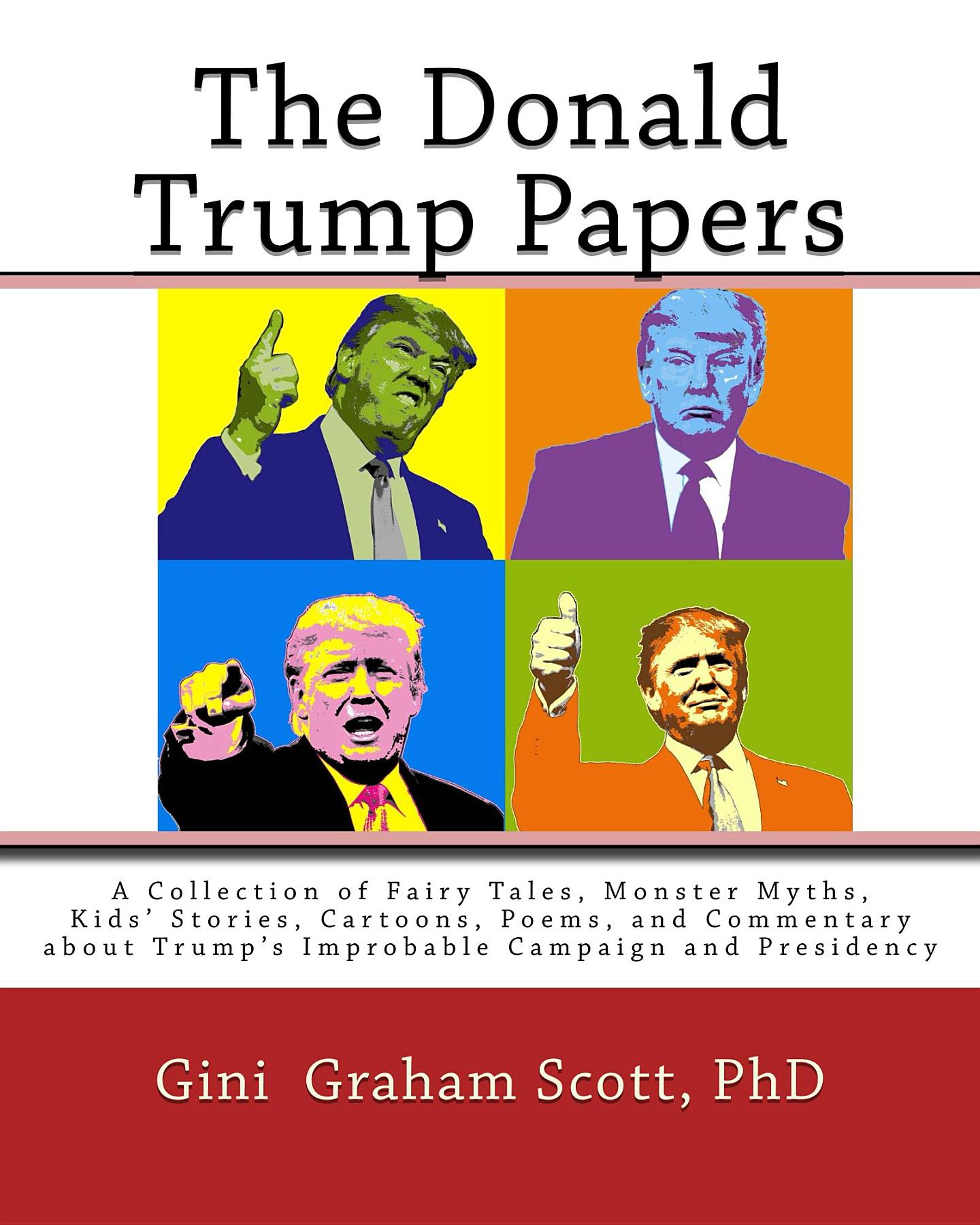
The Donald Trump Papers THE DONALD TRUMP PAPERS is a collection of fairy tales, monster myths, kids’ stories, cartoons, poems, and commentary about Trump’s improbable campaign and presidency. It features thoughts, along with photos and illustrations, on recent news about Trump’s campaign, election, and first months of taking office. Today, as the U.S. faces all kinds of challenges and the White House has been in continuous conflict and chaos, the topics covered in these papers are more relevant than ever. The book is divided into these sections: - Fairy tales and myths, including “Little Red Riding Hood and the Big Bad Trump,†“Three Little Pigs and the Big Bad Trump,†and “Chicken Little and the Boy Who Cried Trump†- Children’s stories for adults, featuring “The Battles of Donnie and Teddy†- Cartoon books, featuring “Trump Is Extinct…or May Be Soon!†“Trump Is Nuts!†and “Trump Is an Animal!†- Poems, including “Dear Donald Trump, What’s Wrong with the FBI?†and “Dear Donald Trump, Are We Going to War? The author Gini Graham Scott began writing these papers as a columnist for the Huffington Post, and she teamed up with artist Nick Alexander who contributed most of the illustrations. She is the author of over 150 books, 50+ with traditional publishers, and 150+ with her company Changemakers Publishing, which specializes in business, self-help, and social trends. POLITICAL SCIENCE,Political Process,Political Parties

The Impostors NATIONAL BESTSELLER: USA Today, Publishers Weekly, and San Francisco Chronicle bestseller The award-winning producer of The Rachel Maddow Show exposes the Republican Party as a gang of impostors who have abandoned their duty to govern, gravely endangering America For decades, American voters innocently assumed the two major political parties were equally mature and responsible governing entities, ideological differences aside. That belief is due for an overhaul: in recent years, the Republican Party has undergone an astonishing metamorphosis, one so baffling and complete that few have fully reckoned with the reality and its consequences. Republicans, simply put, have quit governing. As MSNBC's Steve Benen charts in his groundbreaking new book, the contemporary GOP has become a "post-policy party." Republicans are effectively impostors, presenting themselves as officials who are ready to take seriously the substance of problem solving, but whose sole focus is the pursuit and maintenance of power. Astonishingly, they are winning–at the cost of pushing the political system to the breaking point. Despite having billed itself as the "party of ideas," the Republican Party has walked away from the hard but necessary work of policymaking. It is disdainful of expertise and hostile toward evidence and arithmetic. It is tethered to few, if any, meaningful policy preferences. It does not know, and does not care, about how competing proposals should be crafted, scrutinized, or implemented. This policy nihilism dominated the party's posture throughout Barack Obama's presidency, which in turn opened the door to Donald Trump -- who would cement the GOP's post-policy status in ways that were difficult to even imagine a few years earlier. The implications of this approach to governance are all-encompassing. Voters routinely elect Republicans such as Mitch McConnell and Mike Pence to powerful offices, expecting GOP policymakers to have the technocratic wherewithal to identify problems, weigh alternative solutions, forge coalitions, accept compromises, and apply some level of governmental competence, if not expertise. The party has consistently proven those hopes misguided. The result is an untenable political model that's undermining the American policymaking process and failing to serve the public's interests. The vital challenge facing the civil polity is coming to terms with the party's collapse as a governing entity and considering what the party can do to find its policymaking footing anew. The Impostors serves as a devastating indictment of the GOP's breakdown, identifying the culprits, the crisis, and its effects, while challenging Republicans with an imperative question: Are they ready to change direction? As Benen writes, "A great deal is riding on their answer." POLITICAL SCIENCE,Political Process,Political Parties
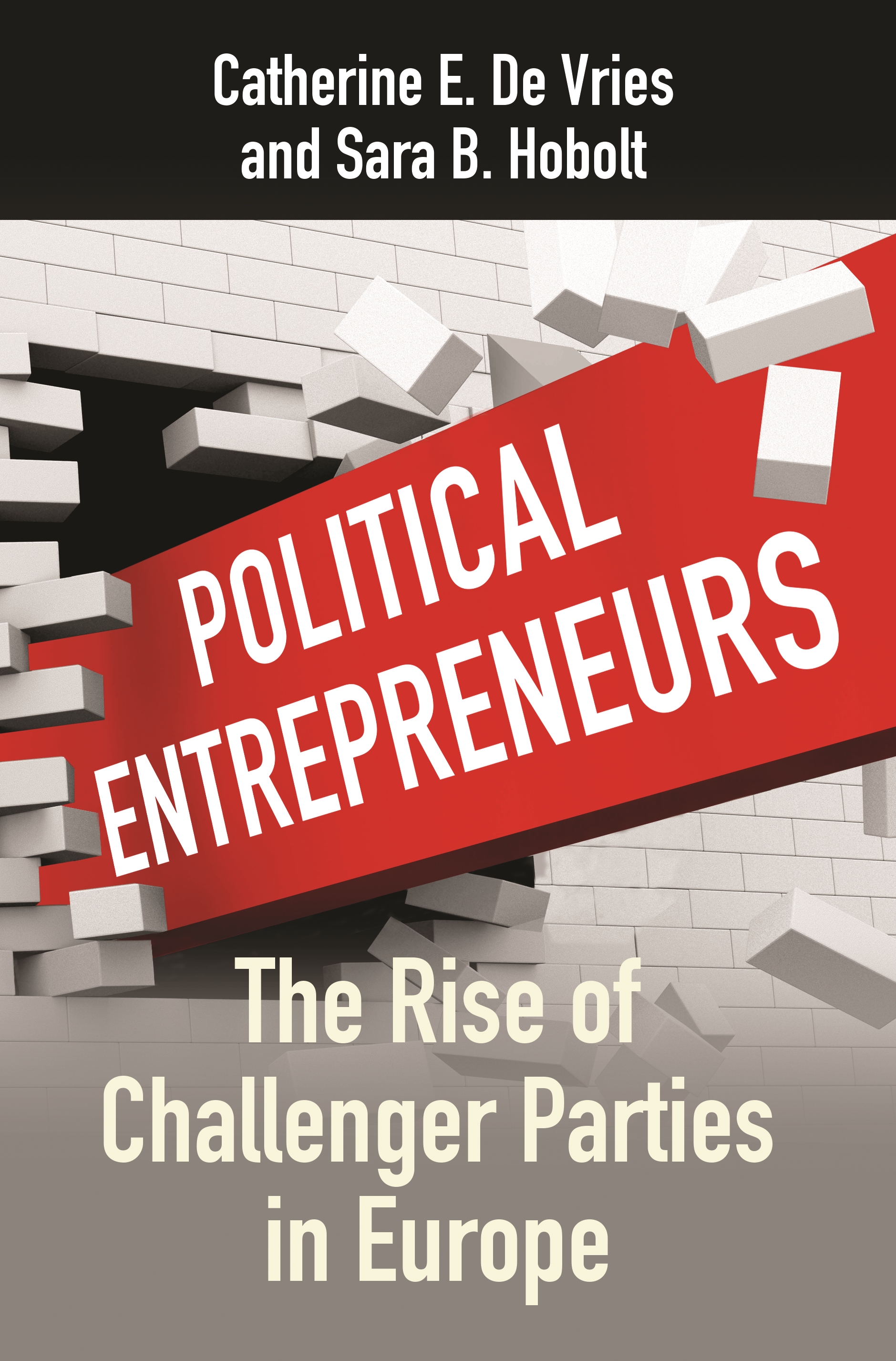
Political Entrepreneurs How challenger parties, acting as political entrepreneurs, are changing European democracies Challenger parties are on the rise in Europe, exemplified by the likes of Podemos in Spain, the National Rally in France, the Alternative for Germany, or the Brexit Party in Great Britain. Like disruptive entrepreneurs, these parties offer new policies and defy the dominance of established party brands. In the face of these challenges and a more volatile electorate, mainstream parties are losing their grip on power. In this book, Catherine De Vries and Sara Hobolt explore why some challenger parties are so successful and what mainstream parties can do to confront these political entrepreneurs. Drawing analogies with how firms compete, De Vries and Hobolt demonstrate that political change is as much about the ability of challenger parties to innovate as it is about the inability of dominant parties to respond. Challenger parties employ two types of innovation to break established party dominance: they mobilize new issues, such as immigration, the environment, and Euroscepticism, and they employ antiestablishment rhetoric to undermine mainstream party appeal. Unencumbered by government experience, challenger parties adapt more quickly to shifting voter tastes and harness voter disenchantment. Delving into strategies of dominance versus innovation, the authors explain why European party systems have remained stable for decades, but also why they are now increasingly under strain. As challenger parties continue to seek to disrupt the existing order, Political Entrepreneurs shows that their ascendency fundamentally alters government stability and democratic politics. POLITICAL SCIENCE,Political Process,Political Parties

How Trump Happened Racism. Sexism. Russian interference. A few thousand votes in key swing states. Political experts Steven Schier and Todd Eberly step back to trace the factors driving the stunning 2016 election of Donald Trump, arguing that Trump’s victory was decades in the making. Essential reading for anyone seeking to understand the current political landscape. POLITICAL SCIENCE,Political Process,Political Parties

Left Out 'Unquestionably the political book of the year' Tim Shipman 'An outstanding, balanced account of the Corbyn leadership' Aaron Bastani Left Out is the first full account of Labour's recent transformation and historic defeat. The 2017 parliament began with Labour on the precipice of power, and its left-most fringe - for so long alienated within its own party - closer to government than it had ever been. It ended with them even farther away than they started. From the peak of Jeremy Corbyn's popularity and the shock hung parliament of 2017 to Labour's humbling in 2019 and the election of Keir Starmer, Left Out draws on unrivalled access throughout the party and to both leaders' inner circles to provide a blistering narrative exposé of the Labour Party during one of the most tumultuous and significant episodes in its history. It reveals a party riven by factionalism and at war over ideology, then incapacitated by crisis and indecision. From the plotting of the break-away Independent Group to the inaction and despair over accusations of anti-Semitism, from complaints of sexual harassment and bullying to foiled coups and furious disagreements over Brexit, the reader is in the room as tempers fray and tensions boil over, as sworn enemies forge unlikely alliances and lifelong friendships are tested to breaking-point. At the heart of the book is Corbyn himself, a man whose like had never been seen at the top of British politics - and is unlikely to ever be seen again. Heroised for his principles by some, derided as an idealist by others, the loyalty and hatred he inspired changed not only the party but the nation. Intimately drawn and brilliantly told, Left Out is the revelatory inside account of how Labour became the party it is today and of the greatest experiment seen in British politics for a generation. POLITICAL SCIENCE,Political Process,Political Parties

Do They Make a Difference? The aim of this book is to contribute to theoretical and empirical research in political science by bringing together a variety of contributions about the influence of RRPP in terms of policies on their core issues. POLITICAL SCIENCE,Political Process,Political Parties
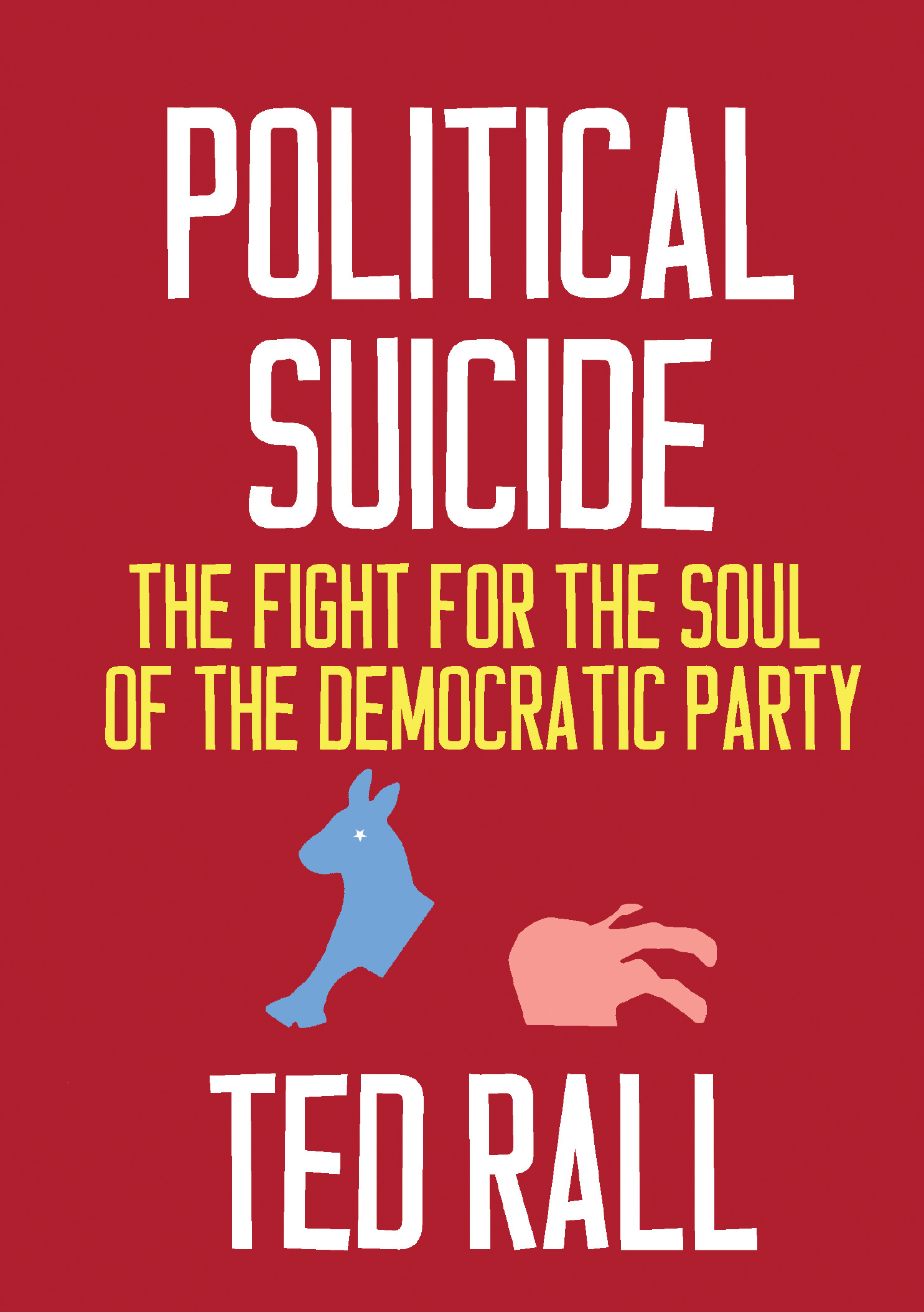
Political Suicide Ted Rall's latest is a no-holds-barred look at the civil war raging within the Democratic Party in the graphic style of his national bestseller, Bernie. There's a split in the Democratic Party. Progressives are surging with ideas and candidates like Bernie Sanders, Elizabeth Warren and Alexandria Ocasio-Cortez. 72 percent of Democratic voters are progressives. But centrists like Tom Perez and the Clintons still run the DNC party apparatus--and they don't want to compromise. Intraparty warfare exploded into the open in 2016. It's even bigger now. The struggle goes back decades, to the New Left and the election of Richard Nixon over George McGovern. It continued with the Democratic establishment's quashing of insurgent progressives like Jesse Jackson, Ralph Nader and Howard Dean. The vast scale of the DNC's secret conspiracy to stop Bernie Sanders in 2016 nomination came out courtesy of WikiLeaks. Will Democrats again become the party of the working person? Or will the corporatists win and continue their domination of electoral politics? Ted Rall gets to the bottom of the story neither the Democrats nor the Republicans want you to know: how the civil war in the Democratic Party poses an existential threat to the two-party system. POLITICAL SCIENCE,Political Process,Political Parties
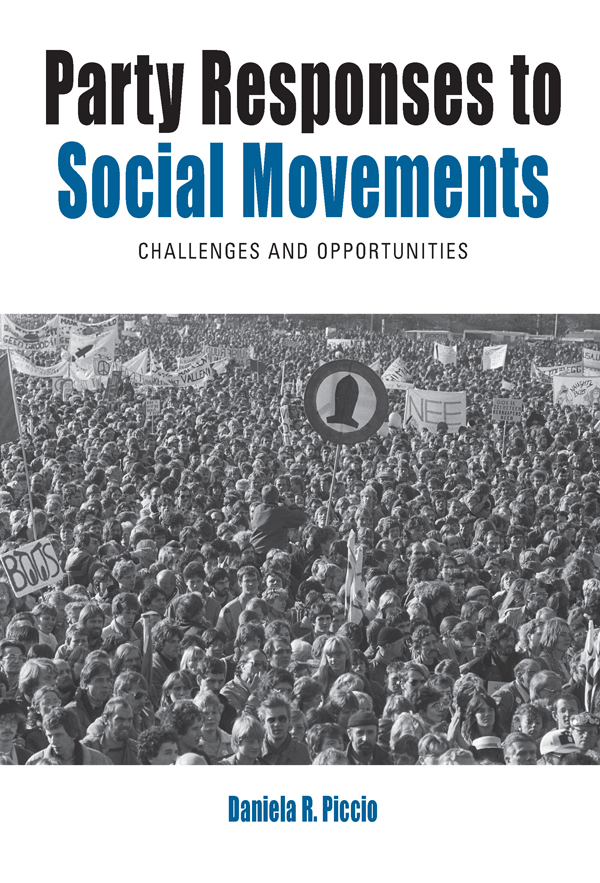
Party Responses to Social Movements Across the West, the explosion of social movement activity since the late 1960s has constituted a “participatory revolution†that has posed profound challenges for formal political parties. Through an analysis of new interviews, institutional documents, and a host of other largely unexploited sources, Daniela R. Piccio provides a rich and empirically grounded exploration of the wide-ranging responses to these movements. Focusing on Italy and the Netherlands since the 1970s, Party Responses to Social Movements demonstrates how political parties have incorporated the demands of movements to a surprising extent, even as both have grappled with fundamental and inevitable tensions between their respective roles and aims. POLITICAL SCIENCE,Political Process,Political Parties
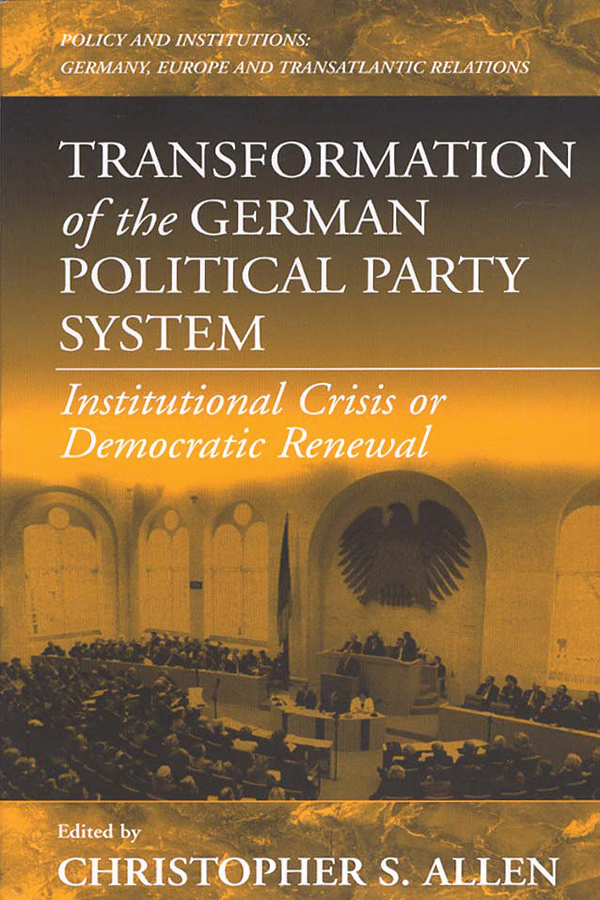
Transformation of the German Political Party System Using German political parties as a prism with which to view institutional change, this collection transcends a single country focus and places the German experience in a comparative and historical framework. Evaluation the performance of the German parties and party system in dealing with problems of integration and legitimation common to all industrialized democracies, it presents a sharp analysis of the effects and incompleteness of German unification. POLITICAL SCIENCE,Political Process,Political Parties
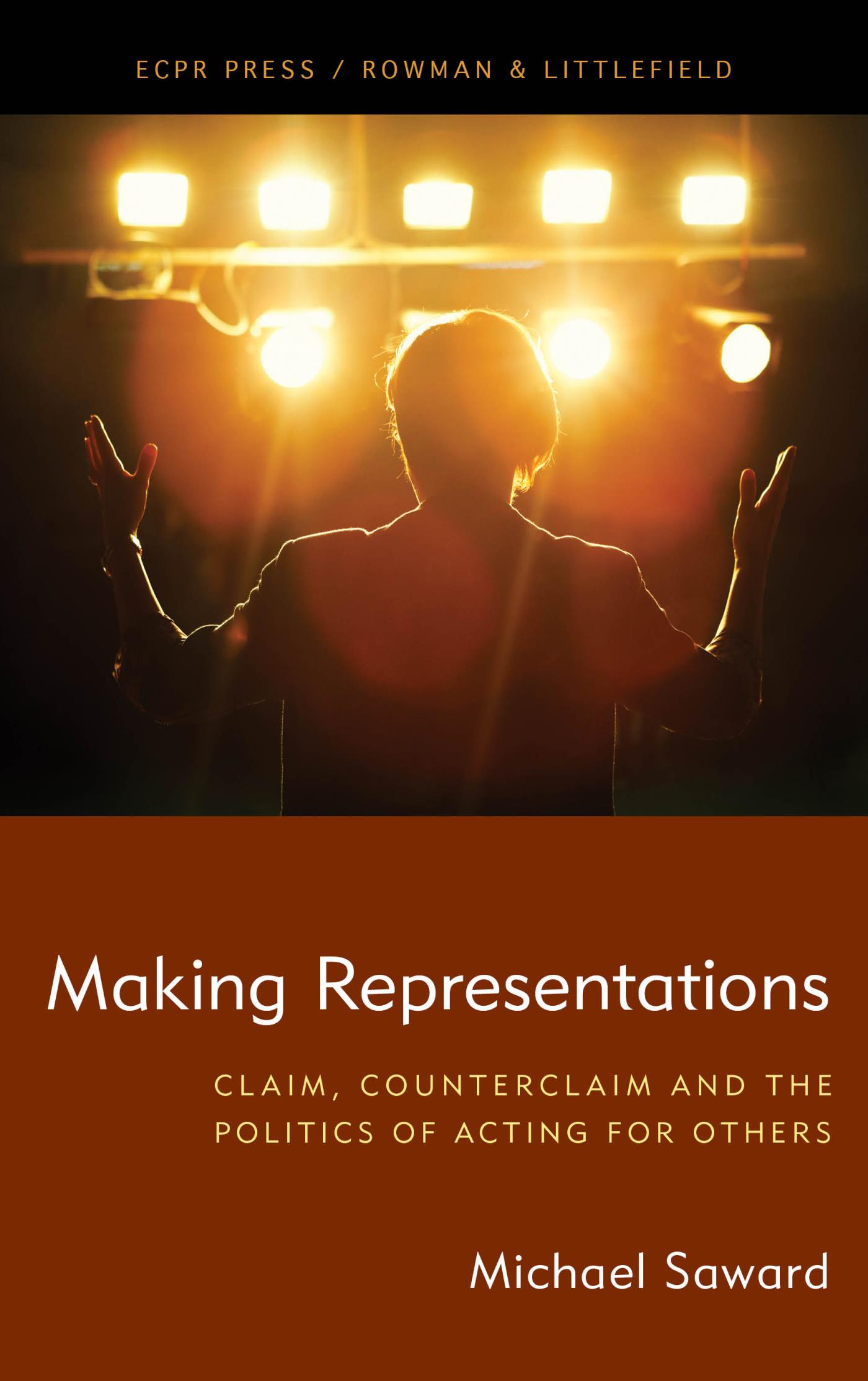
Making Representations Written by an originator of the claims-based approach, this book responds to critical questions about the practice and legitimacy of representation in today’s politics. It also explores critical themes such as performances of representation, becoming representative, and how we can generate political insights by exploring artistic representation. POLITICAL SCIENCE,Political Process,Political Parties

No Place to Hide The New York Times Bestseller In May 2013, Glenn Greenwald set out for Hong Kong to meet an anonymous source who claimed to have astonishing evidence of pervasive government spying and insisted on communicating only through heavily encrypted channels. That source turned out to be the 29-year-old NSA contractor and whistleblower Edward Snowden, and his revelations about the agency's widespread, systemic overreach proved to be some of the most explosive and consequential news in recent history, triggering a fierce debate over national security and information privacy. As the arguments rage on and the government considers various proposals for reform, it is clear that we have yet to see the full impact of Snowden's disclosures. Now for the first time, Greenwald fits all the pieces together, recounting his high-intensity ten-day trip to Hong Kong, examining the broader implications of the surveillance detailed in his reporting for The Guardian, and revealing fresh information on the NSA's unprecedented abuse of power with never-before-seen documents entrusted to him by Snowden himself.Going beyond NSA specifics, Greenwald also takes on the establishment media, excoriating their habitual avoidance of adversarial reporting on the government and their failure to serve the interests of the people. Finally, he asks what it means both for individuals and for a nation's political health when a government pries so invasively into the private lives of its citizens—and considers what safeguards and forms of oversight are necessary to protect democracy in the digital age. Coming at a landmark moment in American history, No Place to Hide is a fearless, incisive, and essential contribution to our understanding of the U.S. surveillance state. POLITICAL SCIENCE,Privacy & Surveillance (see also SOCIAL SCIENCE,Privacy & Surveillance)
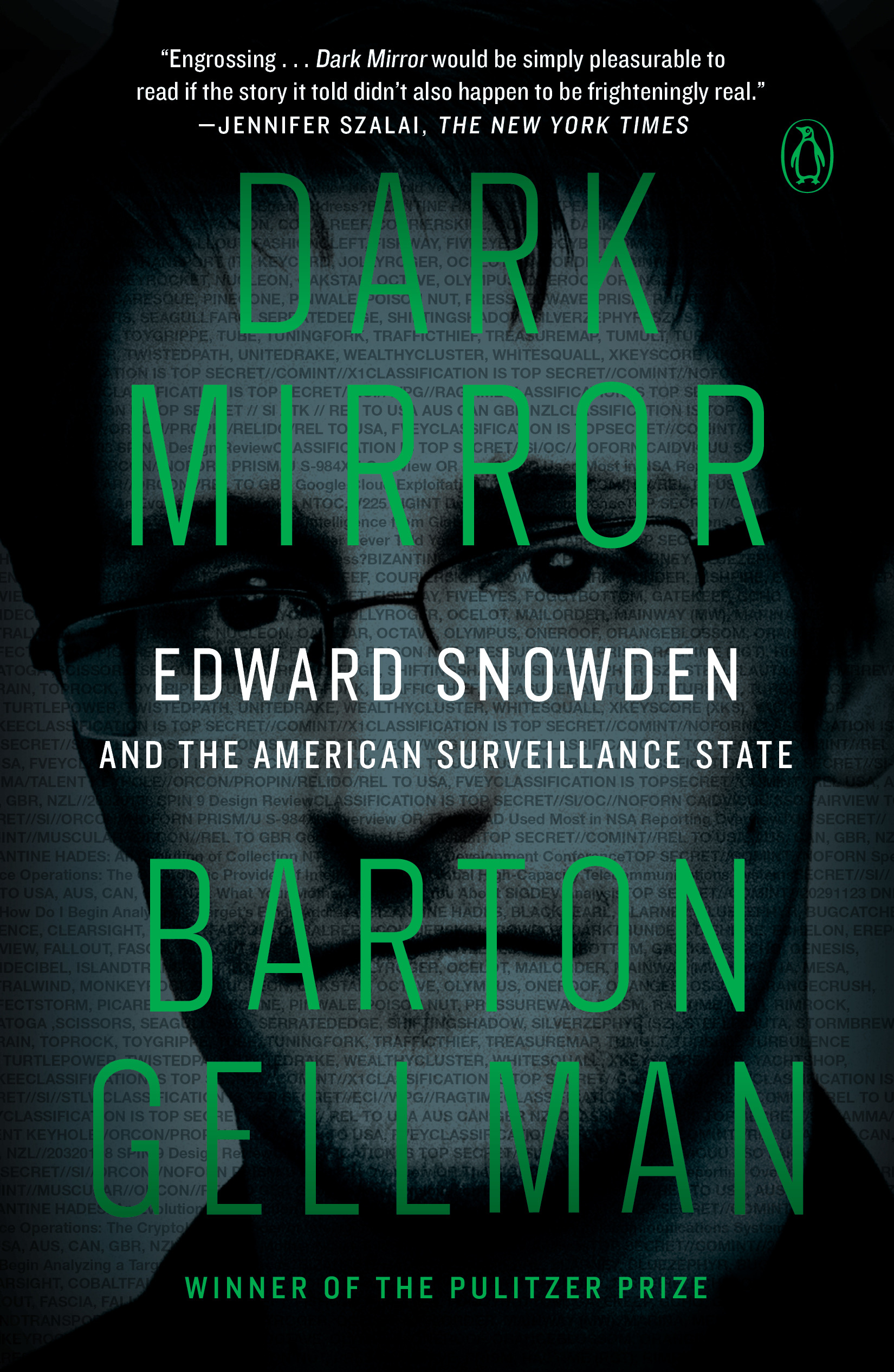
Dark Mirror From the three-time Pulitzer Prize-winning author of the New York Times bestseller Angler, who unearthed the deepest secrets of Edward Snowden's NSA archive, the first master narrative of the surveillance state that emerged after 9/11 and why it matters, based on scores of hours of conversation with Snowden and groundbreaking reportage in Washington, London, Moscow and Silicon Valley Edward Snowden chose three journalists to tell the stories in his Top Secret trove of NSA documents: Barton Gellman of The Washington Post, Glenn Greenwald of The Guardian and filmmaker Laura Poitras, all of whom would share the Pulitzer Prize for Public Service. Poitras went on to direct the Oscar-winning Citizen Four. Greenwald wrote an instant memoir and cast himself as a pugilist on Snowden's behalf. Barton Gellman took his own path. Snowden and his documents were the beginning, not the end, of a story he had prepared his whole life to tell. More than 20 years as a top investigative journalist armed him with deep sources in national security and high technology. New sources reached out from government and industry, making contact on the same kinds of secret, anonymous channels that Snowden used. Gellman's old reporting notes unlocked new puzzles in the NSA archive. Long days and evenings with Snowden in Moscow revealed a complex character who fit none of the stock images imposed on him by others. Gellman now brings his unique access and storytelling gifts to a true-life spy tale that touches us all. Snowden captured the public imagination but left millions of people unsure what to think. Who is the man, really? How did he beat the world's most advanced surveillance agency at its own game? Is government and corporate spying as bad as he says? Dark Mirror is the master narrative we have waited for, told with authority and an inside view of extraordinary events. Within it is a personal account of the obstacles facing the author, beginning with Gellman's discovery of his own name in the NSA document trove. Google notifies him that a foreign government is trying to compromise his account. A trusted technical adviser finds anomalies on his laptop. Sophisticated impostors approach Gellman with counterfeit documents, attempting to divert or discredit his work. Throughout Dark Mirror, the author describes an escalating battle against unknown digital adversaries, forcing him to mimic their tradecraft in self-defense. Written in the vivid scenes and insights that marked Gellman's bestselling Angler, Dark Mirror is an inside account of the surveillance-industrial revolution and its discontents, fighting back against state and corporate intrusions into our most private spheres. Along the way it tells the story of a government leak unrivaled in drama since All the President's Men. POLITICAL SCIENCE,Privacy & Surveillance (see also SOCIAL SCIENCE,Privacy & Surveillance)

Surveillance Valley The internet is the most effective weapon the government has ever built. In this fascinating book, investigative reporter Yasha Levine uncovers the secret origins of the internet, tracing it back to a Pentagon counterinsurgency surveillance project. A visionary intelligence officer, William Godel, realized that the key to winning the war in Vietnam was not outgunning the enemy, but using new information technology to understand their motives and anticipate their movements. This idea -- using computers to spy on people and groups perceived as a threat, both at home and abroad -- drove ARPA to develop the internet in the 1960s, and continues to be at the heart of the modern internet we all know and use today. As Levine shows, surveillance wasn't something that suddenly appeared on the internet; it was woven into the fabric of the technology. But this isn't just a story about the NSA or other domestic programs run by the government. As the book spins forward in time, Levine examines the private surveillance business that powers tech-industry giants like Google, Facebook, and Amazon, revealing how these companies spy on their users for profit, all while doing double duty as military and intelligence contractors. Levine shows that the military and Silicon Valley are effectively inseparable: a military-digital complex that permeates everything connected to the internet, even coopting and weaponizing the antigovernment privacy movement that sprang up in the wake of Edward Snowden. With deep research, skilled storytelling, and provocative arguments, Surveillance Valley will change the way you think about the news -- and the device on which you read it. POLITICAL SCIENCE,Privacy & Surveillance (see also SOCIAL SCIENCE,Privacy & Surveillance)

An Artificial Revolution AI has unparalleled transformative potential to reshape society, our economies and our working lives, but without legal scrutiny, international oversight and public debate, we are sleepwalking into a future written by algorithms which encode racist, sexist and classist biases into our daily lives – an issue that requires systemic political and cultural change to productively address. Leading privacy expert Ivana Bartoletti exposes the reality of the AI revolution, from the low-paid workers who toil to train algorithms to recognise cancerous polyps, to the rise of techno-racism and techno-chauvinism and the symbiotic relationship between AI and right wing populism. An Artificial Revolution is an essential primer to understand the intersection of technology and geopolitical forces shaping the future of civilisation.• Endorsements confirmed from leading UK political figures including David Lammy MP, Yvette Cooper MP, Paul Mason, Frances O’Grady and Ayesha Hazarika• A primer for anyone who is interested to learn more about the relation between AI and ethics, data and privacy, corporate power, politics and tech• Ivana is a sought-after commentator who has appeared on flagship news programmes on the BBC, Sky and other major broadcasters as a privacy and AI ethics expert, who also speaks at conferences around the world on AI and privacy POLITICAL SCIENCE,Privacy & Surveillance (see also SOCIAL SCIENCE,Privacy & Surveillance)

Exploding Data A former Secretary of Homeland Security examines our outdated laws regarding the protection of personal information, and the pressing need for change. Nothing undermines our freedom more than losing control of information about ourselves. And yet, as daily events underscore, we are ever more vulnerable to cyber-attack. In this bracing book, Michael Chertoff makes clear that our laws and policies surrounding the protection of personal information, written for an earlier time, are long overdue for a complete overhaul. On the one hand, the collection of data—more widespread by business than by government, and impossible to stop—should be facilitated as an ultimate protection for society. On the other, standards under which information can be inspected, analyzed, or used must be significantly tightened. In offering his compelling call for action, Chertoff argues that what is at stake is not so much the simple loss of privacy, which is almost impossible to protect, but of individual autonomy—the ability to make personal choices free of manipulation or coercion. Offering vivid stories over many decades that illuminate the three periods of data gathering we have experienced, Chertoff explains the complex legalities surrounding issues of data collection and dissemination today, and charts a path that balances the needs of government, business, and individuals alike. “Surveys the brave new world of data collection and analysis…The world of data as illuminated here would have scared George Orwell.â€â€•Kirkus Reviews “Chertoff has a unique perspective on data security and its implications for citizen rights as he looks at the history of and changes in privacy laws since the founding of the U.S.â€â€”Booklist POLITICAL SCIENCE,Privacy & Surveillance (see also SOCIAL SCIENCE,Privacy & Surveillance)

How Propaganda Works How propaganda undermines democracy and why we need to pay attention Our democracy today is fraught with political campaigns, lobbyists, liberal media, and Fox News commentators, all using language to influence the way we think and reason about public issues. Even so, many of us believe that propaganda and manipulation aren't problems for us—not in the way they were for the totalitarian societies of the mid-twentieth century. In How Propaganda Works, Jason Stanley demonstrates that more attention needs to be paid. He examines how propaganda operates subtly, how it undermines democracy—particularly the ideals of democratic deliberation and equality—and how it has damaged democracies of the past. Focusing on the shortcomings of liberal democratic states, Stanley provides a historically grounded introduction to democratic political theory as a window into the misuse of democratic vocabulary for propaganda's selfish purposes. He lays out historical examples, such as the restructuring of the US public school system at the turn of the twentieth century, to explore how the language of democracy is sometimes used to mask an undemocratic reality. Drawing from a range of sources, including feminist theory, critical race theory, epistemology, formal semantics, educational theory, and social and cognitive psychology, he explains how the manipulative and hypocritical declaration of flawed beliefs and ideologies arises from and perpetuates inequalities in society, such as the racial injustices that commonly occur in the United States. How Propaganda Works shows that an understanding of propaganda and its mechanisms is essential for the preservation and protection of liberal democracies everywhere. POLITICAL SCIENCE,Propaganda
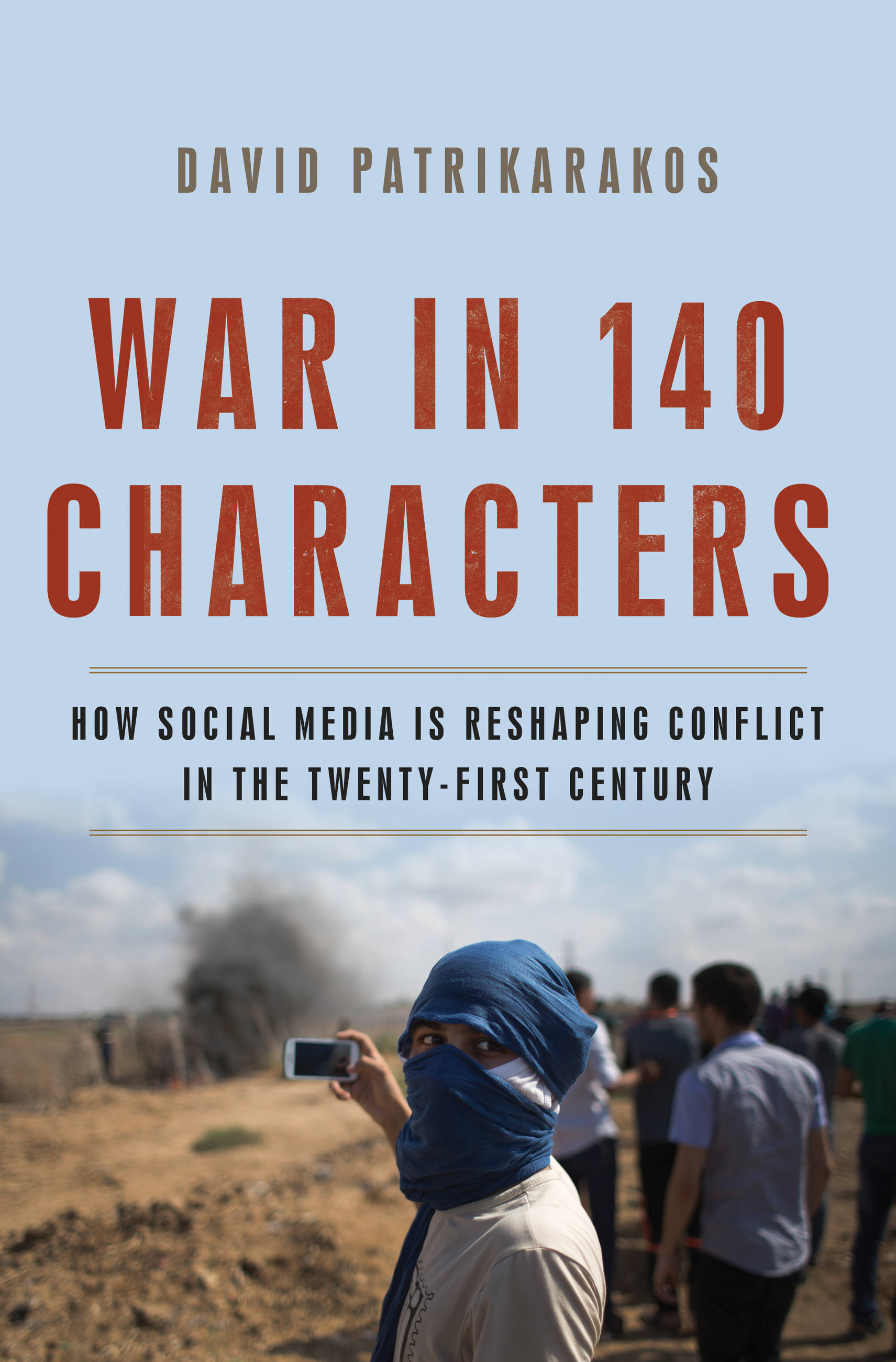
War in 140 Characters A leading foreign correspondent looks at how social media has transformed the modern battlefield, and how wars are fought Modern warfare is a war of narratives, where bullets are fired both physically and virtually. Whether you are a president or a terrorist, if you don't understand how to deploy the power of social media effectively you may win the odd battle but you will lose a twenty-first century war. Here, journalist David Patrikarakos draws on unprecedented access to key players to provide a new narrative for modern warfare. He travels thousands of miles across continents to meet a de-radicalized female member of ISIS recruited via Skype, a liberal Russian in Siberia who takes a job manufacturing "Ukrainian" news, and many others to explore the way social media has transformed the way we fight, win, and consume wars-and what this means for the world going forward. POLITICAL SCIENCE,Propaganda
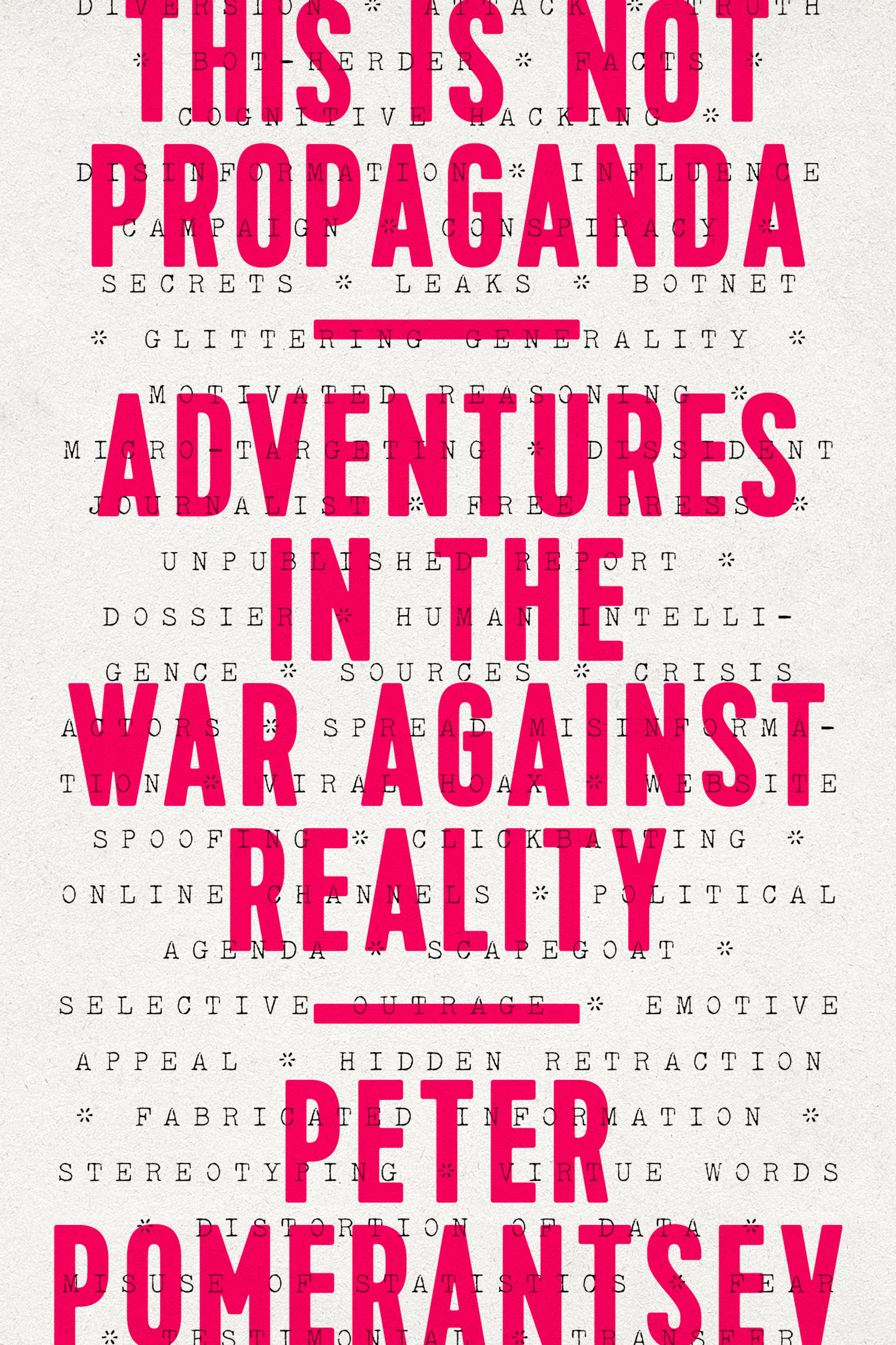
This Is Not Propaganda Learn how the perception of truth has been weaponized in modern politics with this "insightful" account of propaganda in Russia and beyond during the age of disinformation (New York Times). When information is a weapon, every opinion is an act of war. We live in a world of influence operations run amok, where dark ads, psyops, hacks, bots, soft facts, ISIS, Putin, trolls, and Trump seek to shape our very reality. In this surreal atmosphere created to disorient us and undermine our sense of truth, we've lost not only our grip on peace and democracy -- but our very notion of what those words even mean. Peter Pomerantsev takes us to the front lines of the disinformation age, where he meets Twitter revolutionaries and pop-up populists, "behavioral change" salesmen, Jihadi fanboys, Identitarians, truth cops, and many others. Forty years after his dissident parents were pursued by the KGB, Pomerantsev finds the Kremlin re-emerging as a great propaganda power. His research takes him back to Russia -- but the answers he finds there are not what he expected. Blending reportage, family history, and intellectual adventure, This Is Not Propaganda explores how we can reimagine our politics and ourselves when reality seems to be coming apart. POLITICAL SCIENCE,Propaganda

How to Lose a Country ’This is essential’ Margaret Atwood on Twitter ‘She's one of the most acute and perceptive analysts of the furtive growth of fascism. Everyone should know about this’ Philip Pullman ’Vibrates with outrage’ The Times POLITICAL SCIENCE,Propaganda
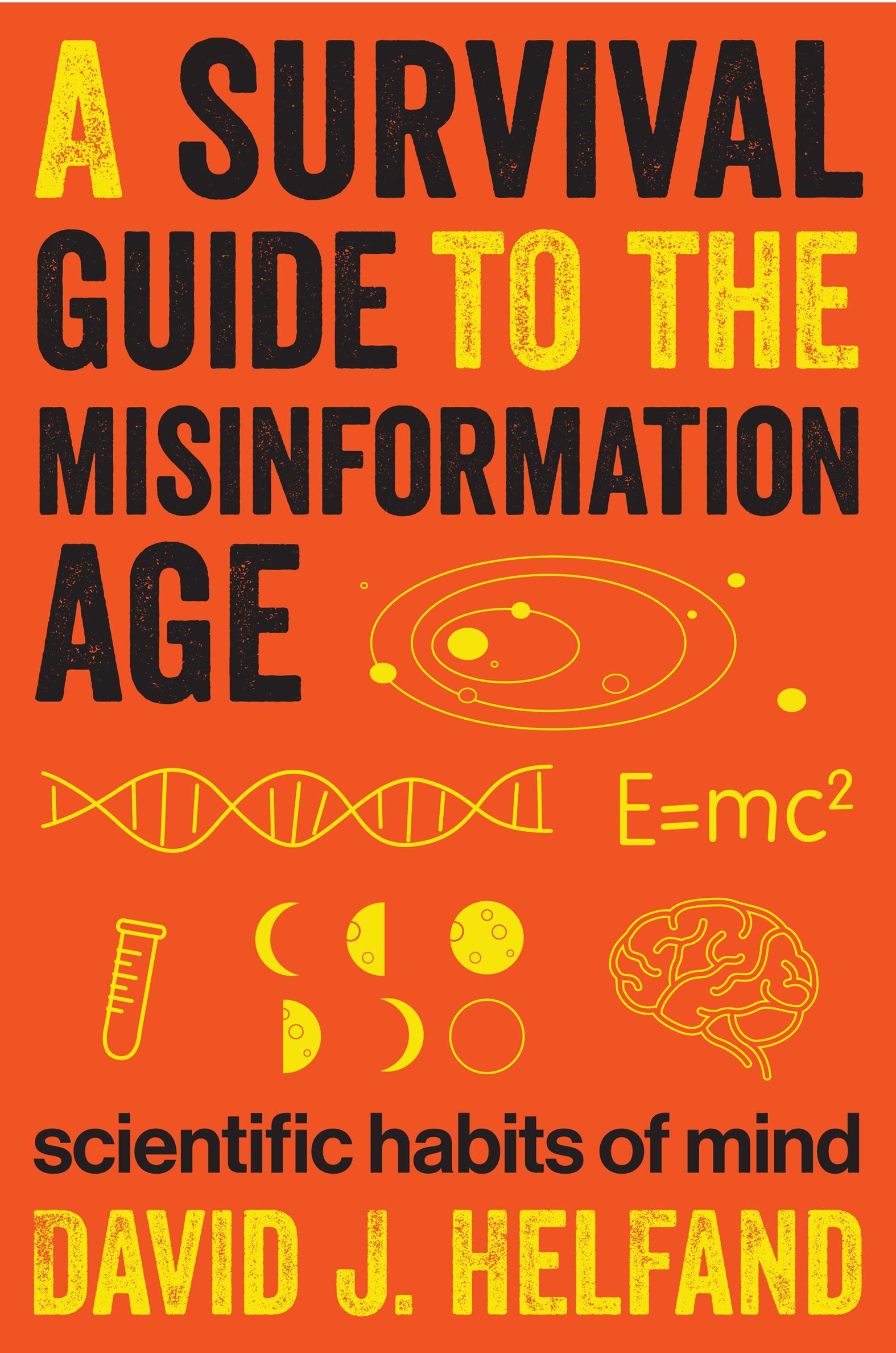
A Survival Guide to the Misinformation Age Learning how to tell news from fake news from fake fake news: An “important and timely†book on protecting ourselves, and society, from the infodemic (Library Journal). We have billions of bytes of data at our fingertips. But how much of it is misinformation—or even disinformation? A lot of it is, and your search engine can’t tell the difference. As a result, an avalanche of misinformation threatens to overwhelm the discourse we so desperately need to address complex social problems such as climate change, the food and water crises, biodiversity collapse, and emerging threats to public health. This book provides an inoculation against the misinformation epidemic by cultivating scientific habits of mind. Anyone can do it—indeed, everyone must do it if our species is to survive on this crowded and finite planet. This survival guide supplies an essential set of apps for the prefrontal cortex while making science both accessible and entertaining. It will dissolve your fear of numbers, demystify graphs, and elucidate the key concepts of probability, all while celebrating the precise use of language and logic. David Helfand, one of our nation’s leading astronomers and science educators, has taught scientific habits of mind to generations in the classroom, where he continues to wage a provocative battle against sloppy thinking and the encroachment of misinformation. “Provides a vital antidote to the ills of misinformation by teaching systematic and rigorous scientific reasoning.†—The Times Literary Supplement POLITICAL SCIENCE,Propaganda

Spoiling for a Fight The rise to power of Eliot Spitzer, the scourge of Wall Street and one of America's most controversial politicians, by the reporter who knows his crusade best Few politicians have burst onto the American scene with as much impact as Eliot Spitzer. He has exposed wrongdoing by stock analysts, mutual fund managers, and insurance brokers, and he has investigated corporations that have misled or defrauded investors and consumers. When federal regulators have fallen down on their responsibilities, Spitzer has stepped in to protect ordinary, middle-class Americans. His actions as the New York State attorney general have made companies change the way they do business, which in turn affects every American with a retirement plan, an insurance policy, or a prescription to fill. No reporter has had better or more complete behind-the-scenes access to Spitzer's operation—and to the strategies that have underpinned his crusade against these powerful forces in the American economy—than Brooke A. Masters of The Washington Post. In Spoiling for a Fight, she presents a portrait that is at once dramatic and revealing, raising the question of whether Spitzer's way of conducting government business is good or bad for America. Combining passion and zeal with a savvy understanding of the press, Spitzer has brought down some of the biggest names in American finance and now has his sights set on higher office. This revelatory book shows Americans how Spitzer has transformed their lives and what his crusade could mean for the future. POLITICAL SCIENCE,Public Affairs & Administration

Memos to the Governor This revised and updated edition of Memos to the Governor is a concise and highly readable guidebook that explains in clear, understandable prose the technical, economic, and political dynamics of budget making. Updated with many new examples of budget quandaries from recent years, this book helps current and future public administrators untangle the knotty processes of budget preparation and implementation. Authors Dall W. Forsythe and Donald J. Boyd outline the budgeting process through a series of memos from a budget director to a newly elected governor—a format that helps readers with little or no background understand complicated financial issues. They cover all of the steps of budget preparation, from strategy to execution, explaining technical vocabulary, and discussing key topics including baseline budgeting, revenue forecasting, and gap-closing options. Forsythe and Boyd bring fresh insights into such issues as the importance of a multiyear strategic budget plan, the impact of the business cycle on state budgets, the tactical problems of getting budgets adopted by legislatures, and, of course, the relationship between governor and budget officer. Memos to the Governor is a painless, practical introduction to budget preparation for students of and practitioners in public administration and public-sector financial management. POLITICAL SCIENCE,Public Affairs & Administration

The SAGE Handbook of Public Administration Now available in paperback: With a particular focus on the utility of scholarly theory and the extent to which government practices inform the development of this theory, this second edition provides a complete review and guide to past and present knowledge in the field POLITICAL SCIENCE,Public Affairs & Administration
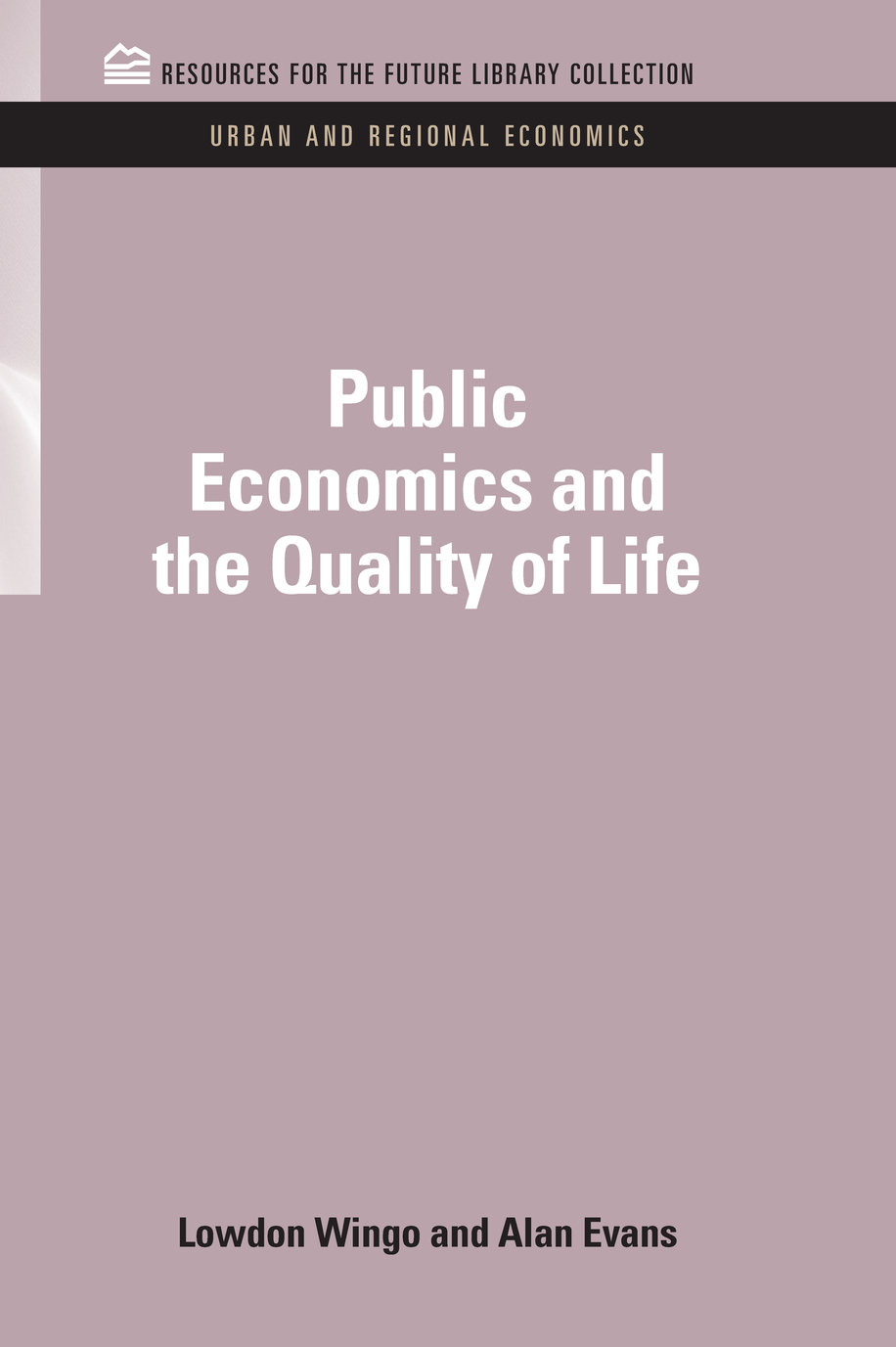
Public Economics and the Quality of Life First Published in 2011. Routledge is an imprint of Taylor & Francis, an informa company. POLITICAL SCIENCE,Public Affairs & Administration

Designing and Conducting Survey Research The industry standard guide, updated with new ideas and SPSS analysis techniques Designing and Conducting Survey Research: A Comprehensive Guide Fourth Edition is the industry standard resource that covers all major components of the survey process, updated to include new data analysis techniques and SPSS procedures with sample data sets online. The book offers practical, actionable guidance on constructing the instrument, administrating the process, and analyzing and reporting the results, providing extensive examples and worksheets that demonstrate the appropriate use of survey and data techniques. By clarifying complex statistical concepts and modern analysis methods, this guide enables readers to conduct a survey research project from initial focus concept to the final report. Public and nonprofit managers with survey research responsibilities need to stay up-to-date on the latest methods, techniques, and best practices for optimal data collection, analysis, and reporting. Designing and Conducting Survey Research is a complete resource, answering the "what", "why", and "how" every step of the way, and providing the latest information about technological advancements in data analysis. The updated fourth edition contains step-by-step SPSS data entry and analysis procedures, as well as SPSS examples throughout the text, using real data sets from real-world studies. Other new information includes topics like: Nonresponse error/bias Ethical concerns and special populations Cell phone samples in telephone surveys Subsample screening and complex skip patterns The fourth edition also contains new information on the growing importance of focus groups, and places a special emphasis on data quality including size and variability. Those who employ survey research methods will find that Designing and Conducting Survey Research contains all the information needed to better design, conduct, and analyze a more effective survey. POLITICAL SCIENCE,Public Affairs & Administration
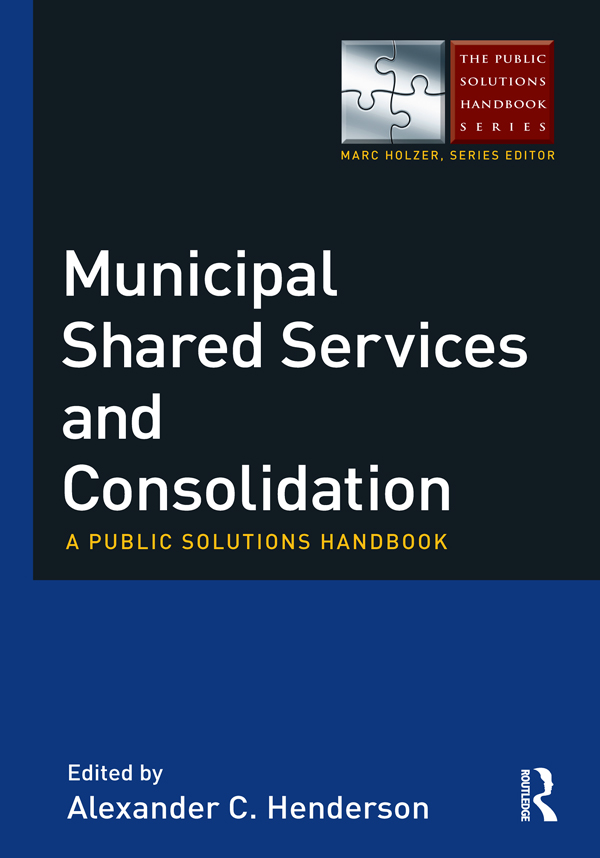
Municipal Shared Services and Consolidation Municipal Shared Services and Consolidation provides a comprehensive and clear review of the theories and practices of structuring and managing complex local government services. Intended for both students and practitioners, this volume in the Public Solutions Handbook Series addresses concepts and processes of shaping collaborative arrangements in public service with goals of effectiveness and efficiency in mind. The Handbook begins with a review of theories of shared services and consolidation, highlighting conceptual foundations, practical barriers, and cultural considerations related to these efforts. Specific, practical advice follows, highlighting the processes of creating, implementing, and managing shared services and consolidation agreements. Municipal Shared Services and Consolidation is exceptionally well written and is amplified by examples, cases, illustrations, and a comprehensive bibliography. POLITICAL SCIENCE,Public Affairs & Administration

E-Government and Websites This book presents a citizen-centric perspective of the dual components of e-government and e-governance. E-government refers to the practice of online public reporting by government to citizens, and to service delivery via the Internet. E-governance represents the initiatives for citizens to participate and provide their opinion on government websites. This volume in the Public Solutions Handbook Series focuses on various e-government initiatives from the United States and abroad, and will help guide public service practitioners in their transformation to e-government. The book provides important recommendations and suggestions oriented towards practitioners, and makes a significant contribution to e-government by showcasing successful models and highlighting the lessons learned in the implementation processes. Chapter coverage includes: * Online fiscal transparency * Performance reporting * Improving citizen participation * Privacy issues in e-governance * Internet voting * E-government at the local level POLITICAL SCIENCE,Public Affairs & Administration
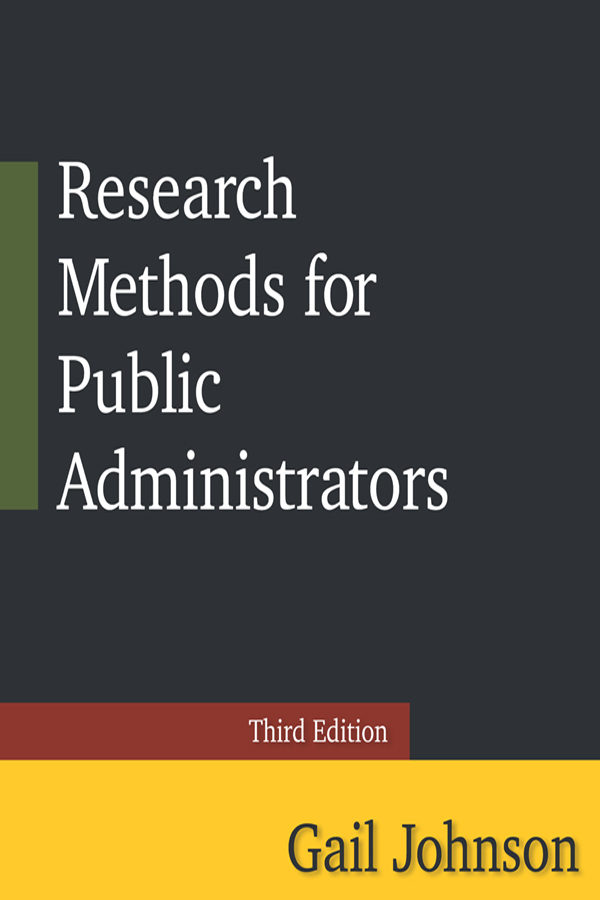
Research Methods for Public Administrators As in previous editions, this highly practical book is written with beginning MPA students and practitioners in mind. It focuses on the interpretation and use of research findings, not just number crunching. It covers the entire research process, from initial questions to final report, in clear, jargon-free language, and includes numerous easy-to-understand examples and exercises that provide opportunities for concrete applications of the concepts. It is solidly grounded in public administration and recognizes both the promise and limitations of research within a political environment. Key features of the book: --It is highly practical and written to accommodate a mix of readers: those who want to become analysts, managers who will oversee research contracts, and citizens who need to know whether to believe the facts and data they read in today's news; --It minimizes the use of jargon and explains difficult concepts in clear language. Plentiful end-of-chapter exercises provide opportunities for concrete application of the concepts; --Key points are highlighted as "takeaway lessons" so readers are reminded about what really matters. The tough questions to ask are suggested in every chapter; --Examples and applications are used throughout the book to illustrate concepts and add topical interest; --It covers the entire research process, from initial questions to the final report. This book demystifies and makes practical the research every public administrator and policy analyst needs to do the job well. Online instructor's materials, including a Test Bank, PowerPoint slides, and a Survey and Documental Analysis (SDA) guide, are also available to adopters. POLITICAL SCIENCE,Public Affairs & Administration
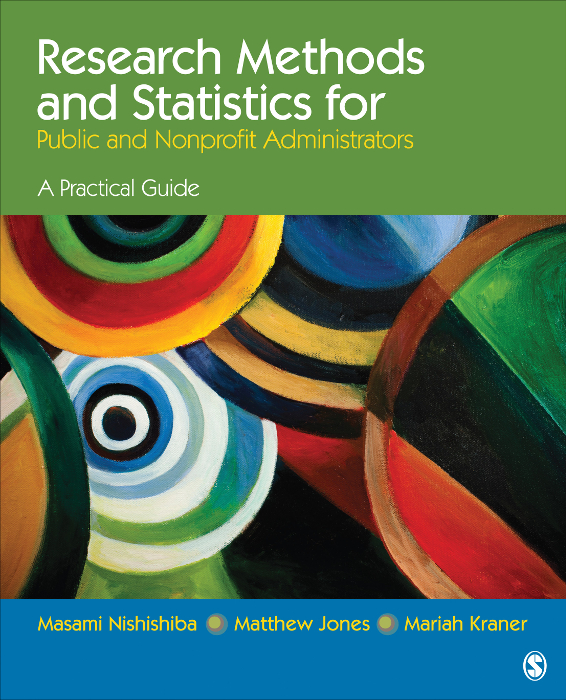
Research Methods and Statistics for Public and Nonprofit Administrators Research Methods and Statistics for Public and Nonprofit Administrators: A Practical Guide is a comprehensive, easy-to-read, core text that thoroughly prepares readers to apply research methods and data analysis to the professional environments of public and non-profit administration. The authors expertly incorporate original case examples to demonstrate concepts using “real actors,†facing specific scenarios, in which research methods must be applied. This unique approach—presented in language accessible to both students new to research as well as current practitioners—guides the reader in fully understanding the research options detailed throughout the text. POLITICAL SCIENCE,Public Affairs & Administration

Crowdsourcing in the Public Sector Crowdsourcing is a term that was coined in 2006 to describe how the commercial sector was beginning to outsource problems or tasks to the public through an open call for solutions over the internet or social media. Crowdsourcing works to generate new ideas or develop innovative solutions to problems by drawing on the wisdom of the many rather than the few. US local government experimented with rudimentary crowdsourcing strategies as early as 1989, but in the last few years local, state, and federal government have increasingly turned to crowdsourcing to enhance citizen participation in problem solving, setting priorities, and decision making. While crowdsourcing in the public sector holds much promise and is part of a larger movement toward more citizen participation in democratic government, many challenges, especially legal and ethical issues, need to be addressed to successfully adapt it for use in the public sector. Daren C. Brabham has been at the forefront of the academic study of crowdsourcing. This book includes extensive interviews with public and private sector managers who have used crowdsourcing. Brabham concludes with a list of the top ten best practices for public managers. POLITICAL SCIENCE,Public Affairs & Administration

An Introduction to Islam An Introduction to Islam, Fourth Edition, provides students with a thorough, unified and topical introduction to the global religious community of Islam. In addition, the author's extensive field work, experience, and scholarship combined with his engaging writing style and passion for the subject also sets his text apart. An Introduction to Islam places Islam within a cultural, political, social, and religious context, and examines its connections with Judeo-Christian morals. Its integration of the doctrinal and devotional elements of Islam enables readers to see how Muslims think and live, engendering understanding and breaking down stereotypes. This text also reviews pre-Islamic history, so readers can see how Islam developed historically. POLITICAL SCIENCE,Public Affairs & Administration

Caught Between the Dog and the Fireplug, or How to Survive Public Service Replete with practical advice for anyone considering a career in federal, state, or local government, Caught between the Dog and the Fireplug, or How to Survive Public Service conveys what life is really like in a public service job. The book is written as a series of lively, entertaining letters of advice from a sympathetic uncle to a niece or nephew embarking on a government career. Kenneth Ashworth draws on more than forty years of public sector experience to provide advice on the daily challenges that future public servants can expect to face: working with politicians, bureaucracy, and the press; dealing with unpleasant and difficult people; leading supervisors as well as subordinates; and maintaining high ethical standards. Ashworth relates anecdotes from his jobs in Texas, California, and Washington, D.C., that illustrate with humor and wit fundamental concepts of public administration. Be prepared, says Ashworth, to encounter all sorts of unexpected situations, from the hostile to the bizarre, from the intimidating to the outrageous. He shows that in the confrontational world of public policymaking and program implementation, a successful career demands disciplined, informed thought, intellectual and personal growth, and broad reading. He demonstrates how, despite the inevitable inefficiencies of a democratic society, those working to shape policy in large organizations can nonetheless effect significant change-and even have fun along the way. The book will interest students and teachers of public administration, public affairs, policy development, leadership, or higher education administration. Ashworth's advice will also appeal to anyone who has ever been caught in a tight spot while working in government service. POLITICAL SCIENCE,Public Affairs & Administration
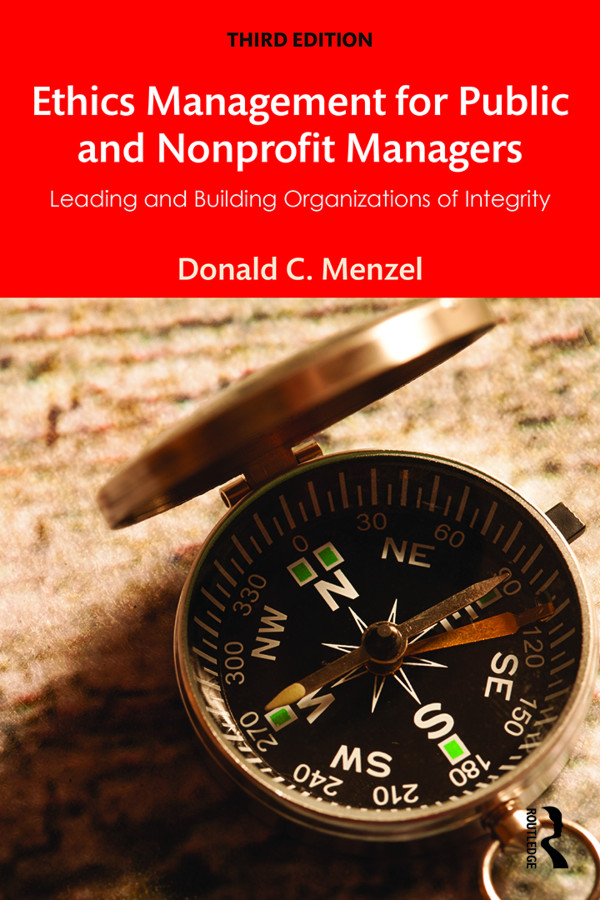
Ethics Management for Public and Nonprofit Managers This practical book is dedicated to building ethical organizations. It has been written for college students preparing for careers in public service as well as for elected and appointed officials, administrators, and career public servants in the United States and elsewhere. Concise and comprehensive, Ethics Management for Public and Nonprofit Managers takes a managerial ethics approach to building and leading ethical public organizations. It includes: a discussion of the U.S. constitutional and administrative environment in which officials carry out their duties; descriptions and assessments of the tools available to elected and appointed officials who are committed to building ethical organizations; an overview of legislative and administrative measures taken by Congress, presidents, the judiciary, and the fifty states to foster ethical governance; unique coverage of ethics management around the world, with a focus on the US, Europe, and Asia; and hands-on skill-building exercises with active learning opportunities that conclude each chapter. This third edition includes a new chapter on ‘achieving ethical competence,’ exploring a wide range of ethical issues that confront public and nonprofit managers in their efforts to lead and build organizations of integrity. Examples and cases from both the public and the nonprofit sectors are incorporated throughout the third edition so that the book acts as a kind of ‘field guide’ for ethical behavior, with descriptions and assessments of the tools available to elected and appointed officials at every level. Accompanying the third edition text is a series of exercises that build ethical competence skills, asking the reader to judge the ethical competence of key actors in cases drawn from recent headlines. POLITICAL SCIENCE,Public Affairs & Administration
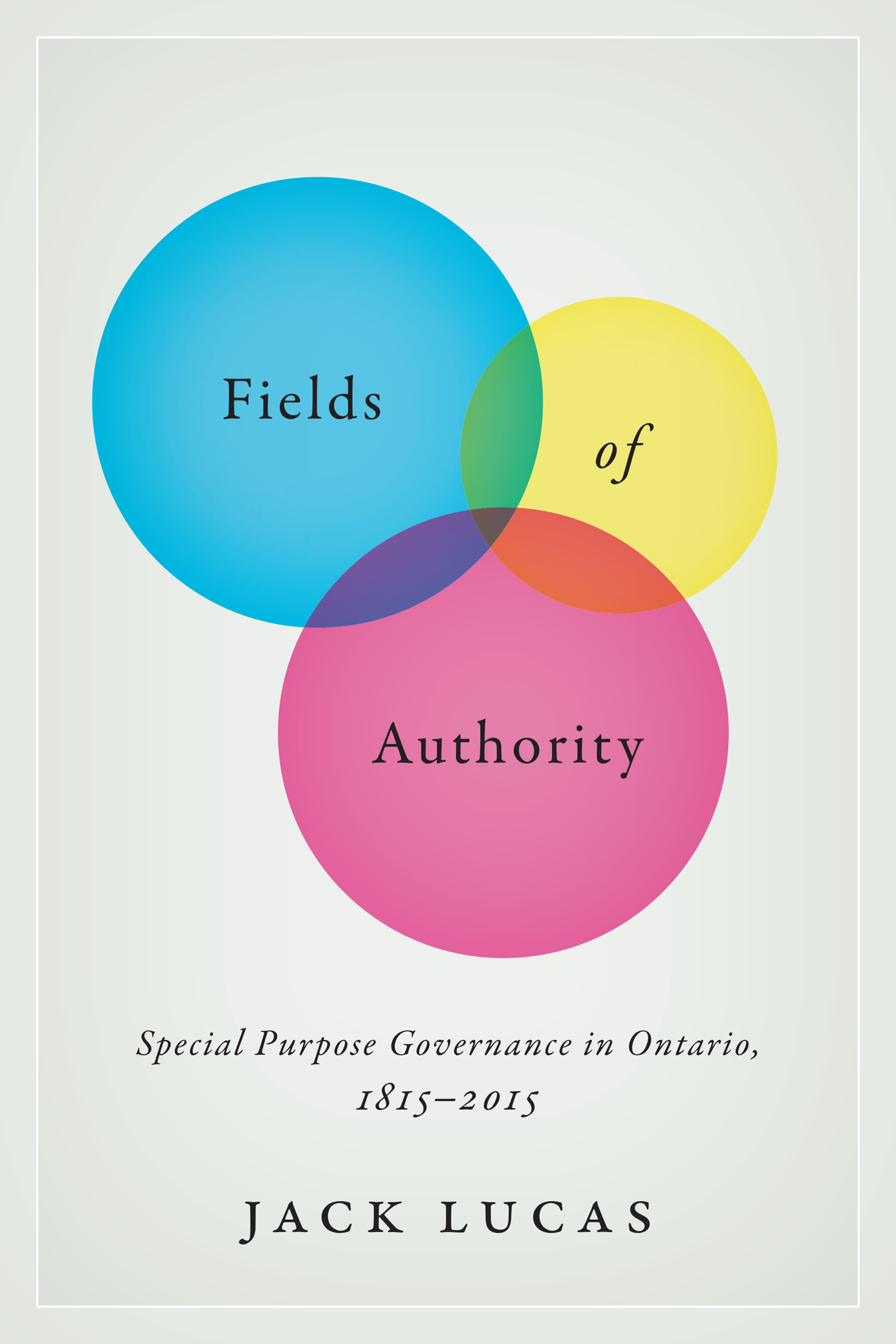
Fields of Authority In Fields of Authority, Jack Lucas provides the first systematic exploration of local special purpose bodies in Ontario. Lucas uses a “policy fields†approach to explain how these local bodies in Ontario have developed from the nineteenth century to the present. POLITICAL SCIENCE,Public Affairs & Administration

It's Time for High-Performance Government Written by leading experts with decades of experience as managers and consultants, It's Time for High Performance Government provides executives, managers, and elected officials at all levels practical advice to improve government performance. POLITICAL SCIENCE,Public Affairs & Administration
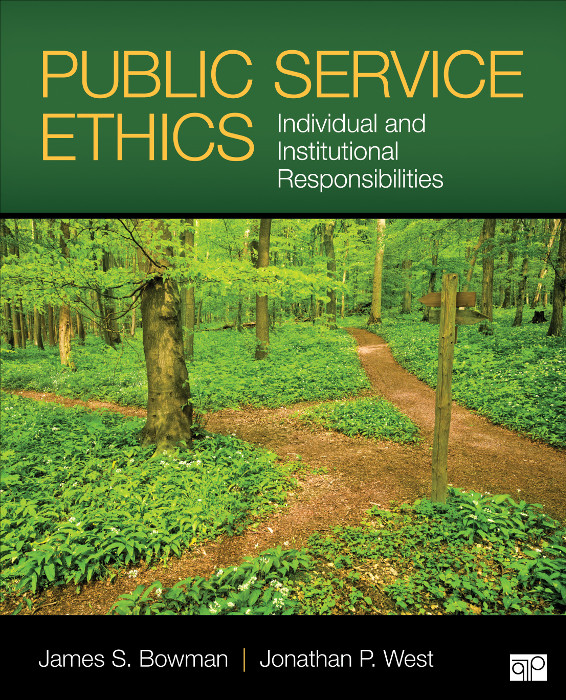
Public Service Ethics Ethics—in all its exemplary and exhausting forms—matters. It deals with the most gripping question in public life: “What is the right thing to do?†In Public Service Ethics: Individual and Institutional Responsibilities, James Bowman and Jonathan West examine individual-centered and organization-focused ethics, applying ideas and ideals from both to contemporary dilemmas. The authors take on controversial issues—from whistle blowing incidents to corruption exposés—to explain how they arise and suggest what can be done about them. They start with the conceptual tools students need to evaluate an ethical dilemma, then analyze individual decision making strategies, and go on to assess institutional ethics programs. The emphasis is not only on the “how to,†but also on the “why.†The ultimate goal is to bolster students’ confidence and prepare them for the ethical problems they will face in the future, by equipping them with the conceptual frameworks and context to approach thorny questions and behave ethically. POLITICAL SCIENCE,Public Affairs & Administration
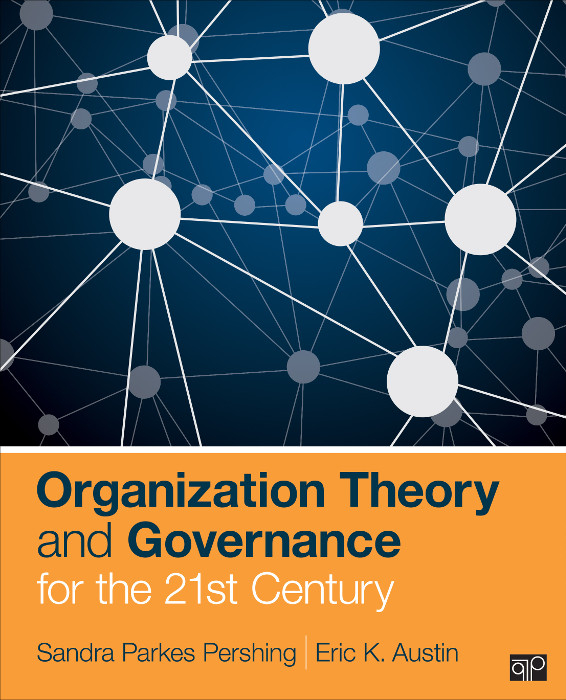
Organization Theory and Governance for the 21st Century Applying organization theory to public and governance organizations, Organization Theory and Governance for the 21st Century presents readers with a conscious and thoughtful awareness of the history and evolving nature of organizations. Authors Sandra Parkes Pershing and Eric Austin address emerging theories rarely touched upon in competing titles, and take a deeper look into assumed theories to give the student a chance to critically consider the consequences these embedded assumptions have for organizational practice. By providing a consistent theoretical grounding and a clear focus on post-traditionalist thinking, the book gives students the background they need to analyze organizational settings and take effective action in the unique setting of contemporary governance. POLITICAL SCIENCE,Public Affairs & Administration
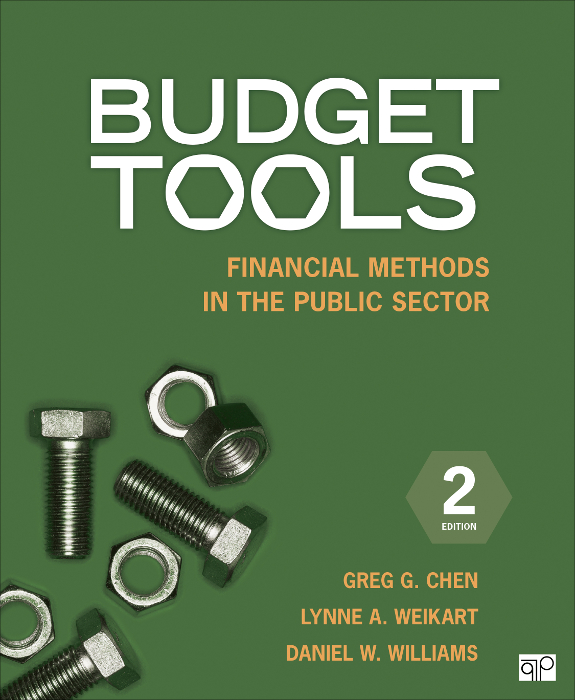
Budget Tools The thoroughly updated and expanded Second Edition of Greg G. Chen, Lynne A. Weikart, and Daniel W. Williams’ Budget Tools: Financial Methods in the Public Sector brings together scores of exercises that will take students through the process of public budgeting, from organizing data through analysis and presentation. This thoroughly revised text has been restructured – it now has 30 compact modules to focus on individual skills and enhance flexibility, and is reorganized to cover more straightforward skills early in the book and more complex tools later on. Using budgets from all levels of government as well as from nonprofit organizations, the authors give students the opportunity to work with real budgeting data to cover a range of topics and skills. Budget Tools provides instruction in the techniques and implementation of budgeting skills at a granular level to support a wide range of approaches to teaching the subject. POLITICAL SCIENCE,Public Affairs & Administration
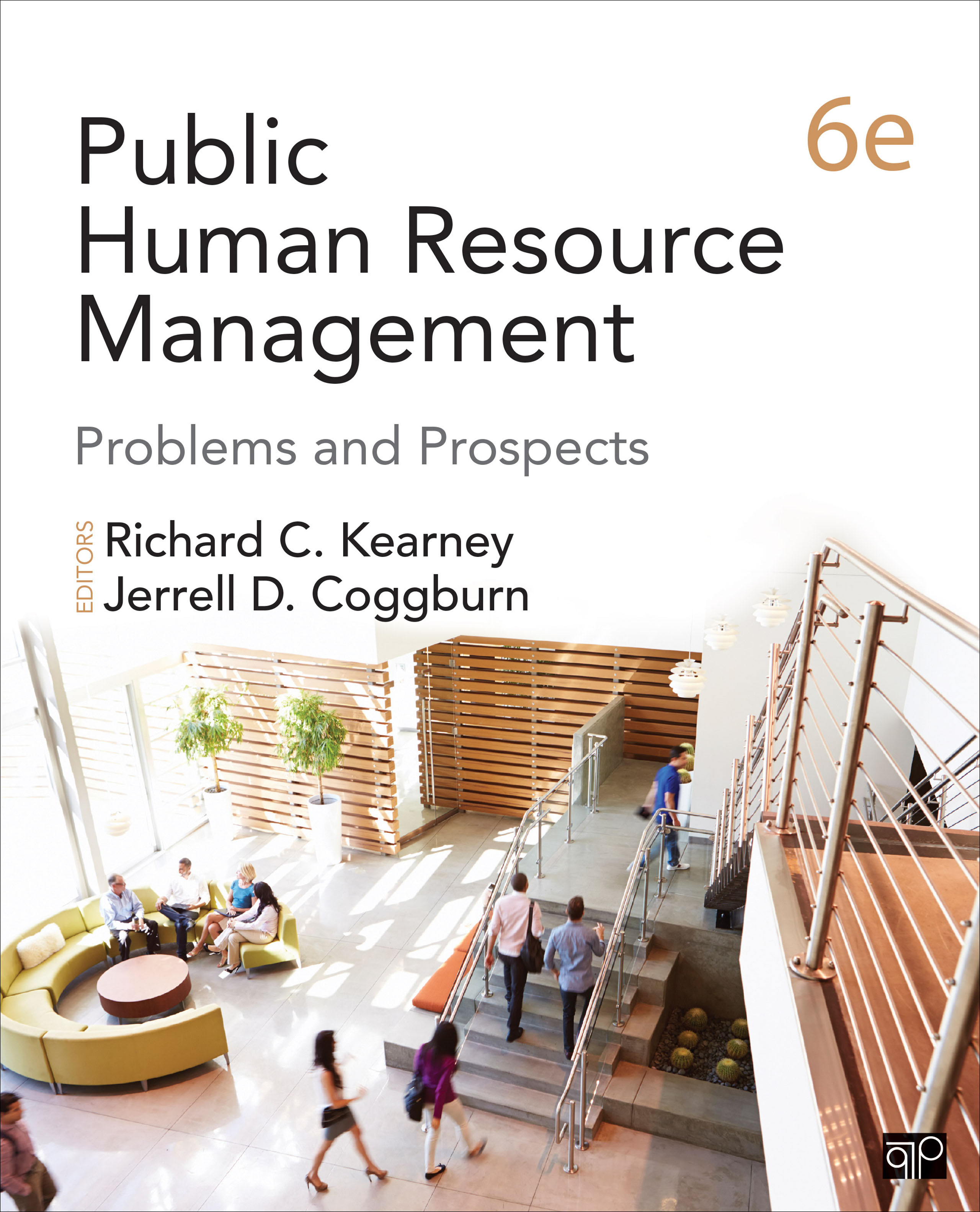
Public Human Resource Management Public Human Resource Management: Problems and Prospects by Richard C. Kearney and Jerrell D. Coggburn brings together exemplary contributors who provide concise essays on major contemporary public human resources management issues. Organized into four parts – setting, techniques, issues and prospects – and covering the major process, function and policy issues in the field, the text offers valuable wisdom to students and practitioners alike. The new edition boasts sixteen new and eleven updated chapters authored by the leading figures in the field as well as by up-and-coming new scholars. POLITICAL SCIENCE,Public Affairs & Administration

Administrative Law Administrative Law: The Sources and Limits of Government Agency Power explains the sources of administrative agency authority in the United States, how agencies make rules, the rights of clients and citizens in agency hearings, and agency interaction with other branches of government. This concise text examines the everyday challenges of administrative responsibilities and provides students with a way to understand and manage the complicated mission that is governance. Written by leading scholar Daniel Feldman, the book avoids technical legal language, but at the same time provides solid coverage of legal principles and exemplar studies, which allows students to gain a clear understanding of a complicated and critical aspect of governance. POLITICAL SCIENCE,Public Affairs & Administration
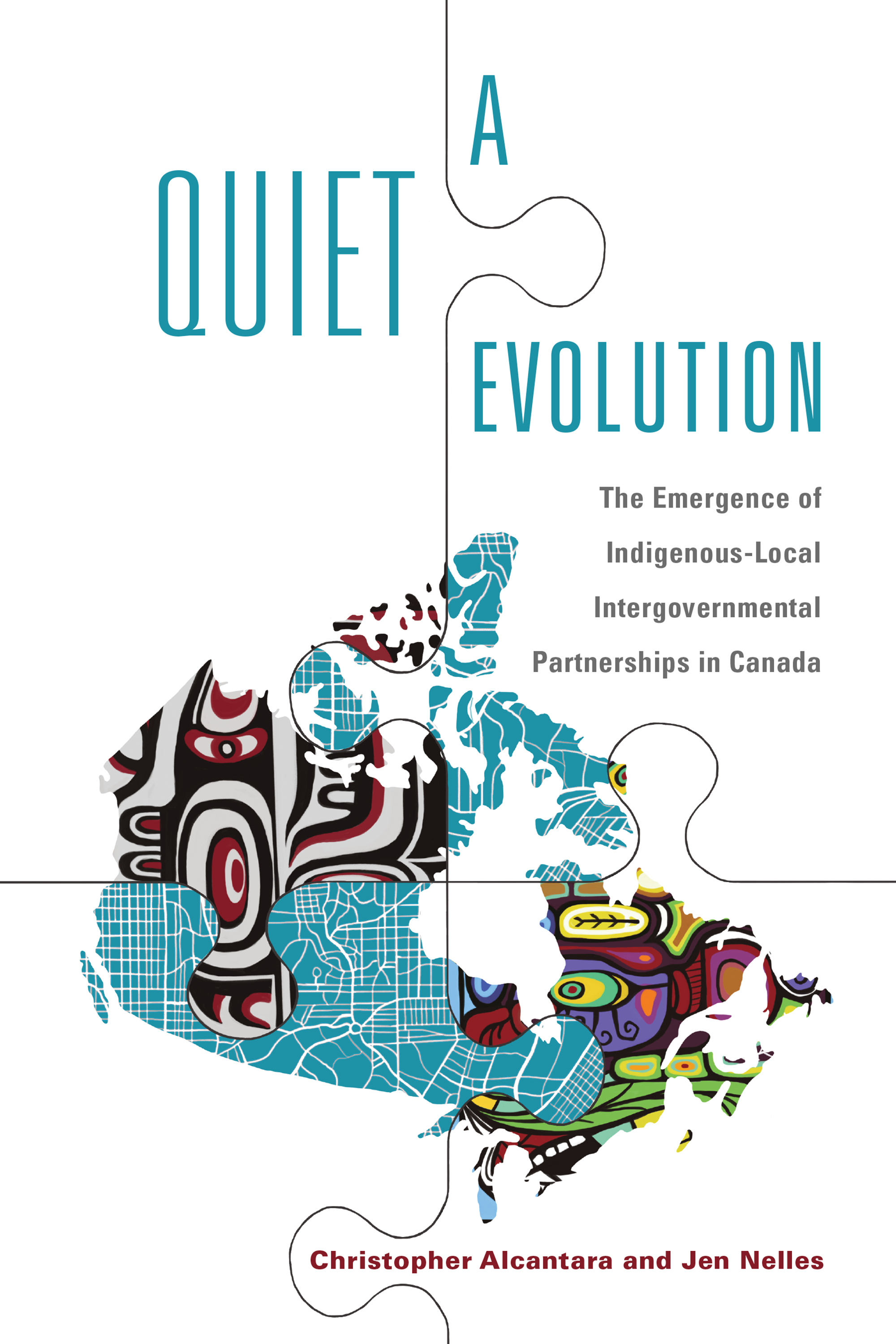
A Quiet Evolution In A Quiet Evolution, Christopher Alcantara and Jen Nelles look closely at hundreds of agreements from across Canada and at four case studies drawn from Ontario, Quebec, and Yukon Territory to explore relationships between Indigenous and local governments. POLITICAL SCIENCE,Public Affairs & Administration
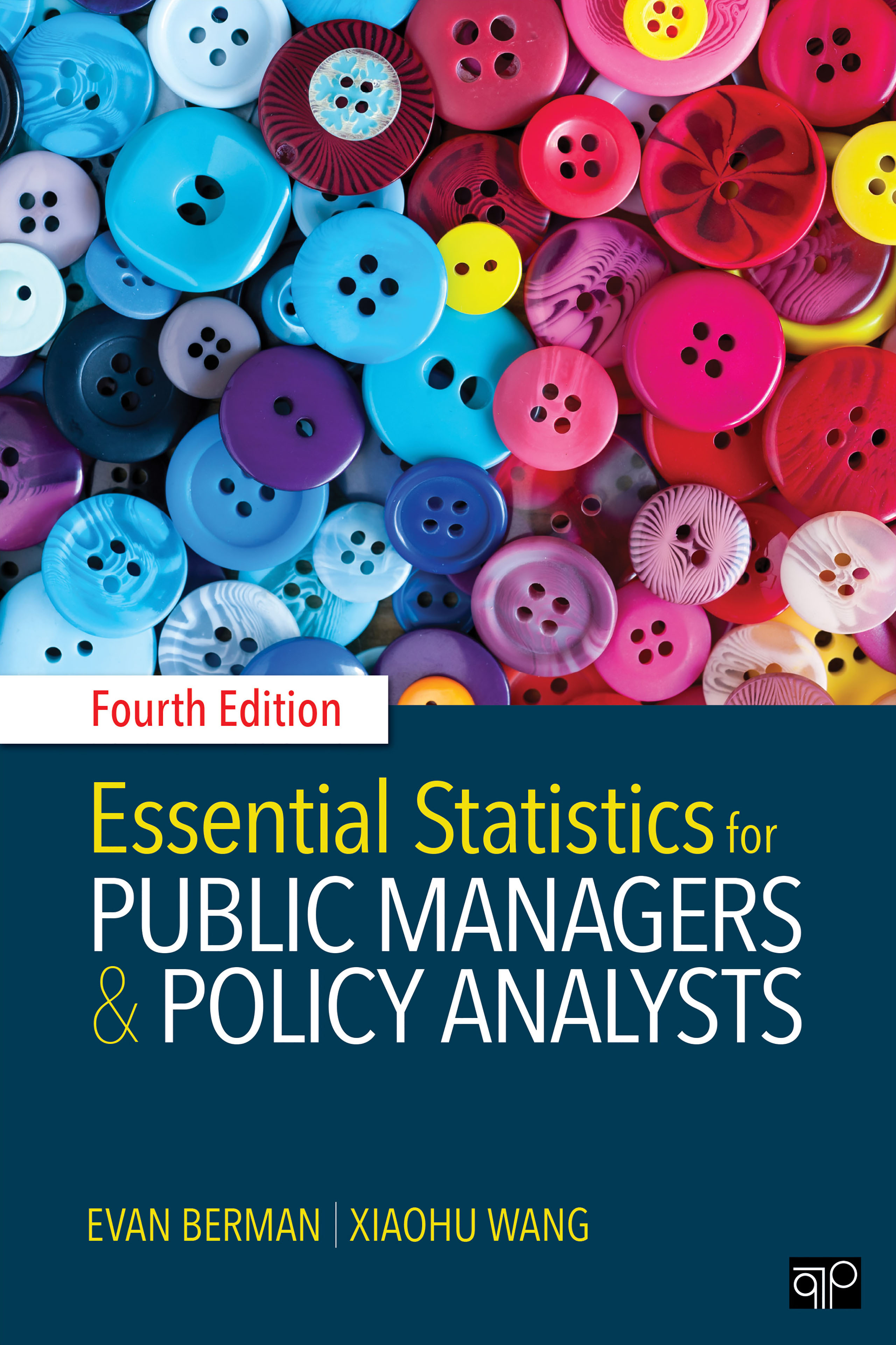
Essential Statistics for Public Managers and Policy Analysts Known for its brevity and student-friendly approach, Essential Statistics for Public Managers and Policy Analysts remains one of the most popular introductory books on statistics for public policy and public administration students, using carefully selected examples tailored specifically for them. The Fourth Edition continues to offer a conceptual understanding of statistics that can be applied readily to the real-life challenges of public administrators and policy analysts. The book provides examples from the areas of human resources management, organizational behavior, budgeting, and public policy to illustrate how public administrators interact with and analyze data. POLITICAL SCIENCE,Public Affairs & Administration

Exercising Essential Statistics Through the use of critical thinking questions and data-based exercises, Evan Berman and Xiaohu Wang’s Exercising Essential Statistics helps students apply the techniques described in Essential Statistics for Public Managers and Policy Analysts, Fourth Edition. This accompanying workbook gives students the opportunity to practice these techniques through hands-on, carefully crafted exercises. Various examples are provided from human resource management, organizational behavior, budgeting, and public policy to illustrate how public administrators interact with and analyze data. The workbook's CD includes seven data sets that cover a range of measures and applications (available in SPSS, SAS, SYSTAT, Stata, and Excel). POLITICAL SCIENCE,Public Affairs & Administration

Collaborative Innovation in the Public Sector Network-based collaboration between public and private stakeholders may bring about a renaissance in creative governance. In this book, Jacob Torfing draws on extensive research to analyze and promote the emerging field of collaborative innovation. His exploration of processes and the roles of specific systems combine the analytical and theoretical. The result is a collection of reflections and propositions that provides a much-needed blueprint for study in this emerging but still-unsettled field. POLITICAL SCIENCE,Public Affairs & Administration

Crossing Boundaries for Intergovernmental Management Today, the work of government often involves coordination at the federal, state, and local levels as well as with contractors and citizens’ groups. This process of governance across levels of government, jurisdictions, and types of actors is called intergovernmental relations, and intergovernmental management (IGM) is the way work is administered in this increasingly complex system. Leading authority Robert Agranoff reintroduces intergovernmental management for twenty-first-century governance to a new generation of scholars, students, and practitioners. POLITICAL SCIENCE,Public Affairs & Administration
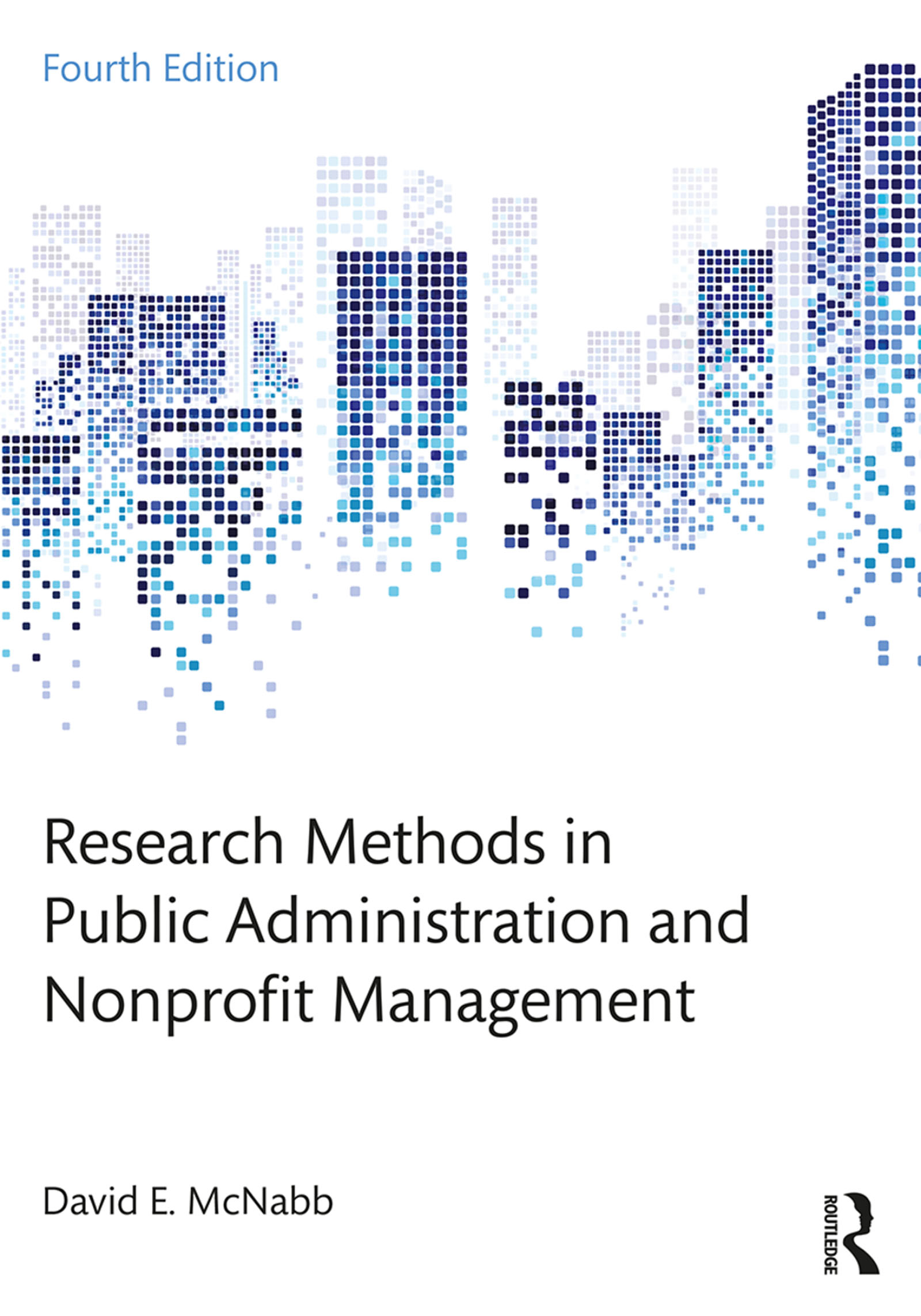
Research Methods in Public Administration and Nonprofit Management Now in a thoroughly revised and refreshed fourth edition, Research Methods in Public Administration and Nonprofit Management is beloved by students and professors alike for its exceptional clarity and accessibility and plentiful illustrations. This new edition integrates quantitative, qualitative, and mixed-methods approaches, as well as specific up-to-date instruction in the use of statistical software programs such as Excel and SPSS. Changes to this edition include: A new section, featuring two new chapters, to explore mixed-methods approaches to research, including fundamentals, research design, data collection, and analyzing and interpreting findings A new, dedicated chapter on Big Data research Updated exhibits and examples throughout the book A new companion website to accompany the book containing PowerPoint slides for each chapter New exhibits, tables, figures, and exercises, as well as key terms and discussion questions at the end of each chapter Research Methods in Public Administration and Nonprofit Management, 4e is an ideal textbook for use in all research methods courses in undergraduate and graduate public administration, public affairs, and nonprofit management courses. POLITICAL SCIENCE,Public Affairs & Administration

The Next Public Administration Written by two of the leading scholars in the field, this book explores public administration in the past, present and future, critically reviewing the modernization of public management reform. It reasserts public administration as an integral component of democratic governance and fostering a state-citizen relationship. Wide-ranging in scope, The Next Public Administration: Extends basic public administration to consider issues associated with management, governance and democracy Covers core public administration concepts and their evolution through time Draws on an international spread of examples, bringing theoretical discussions to life Includes lists of further reading Essential reading for students of public management and public administration. POLITICAL SCIENCE,Public Affairs & Administration
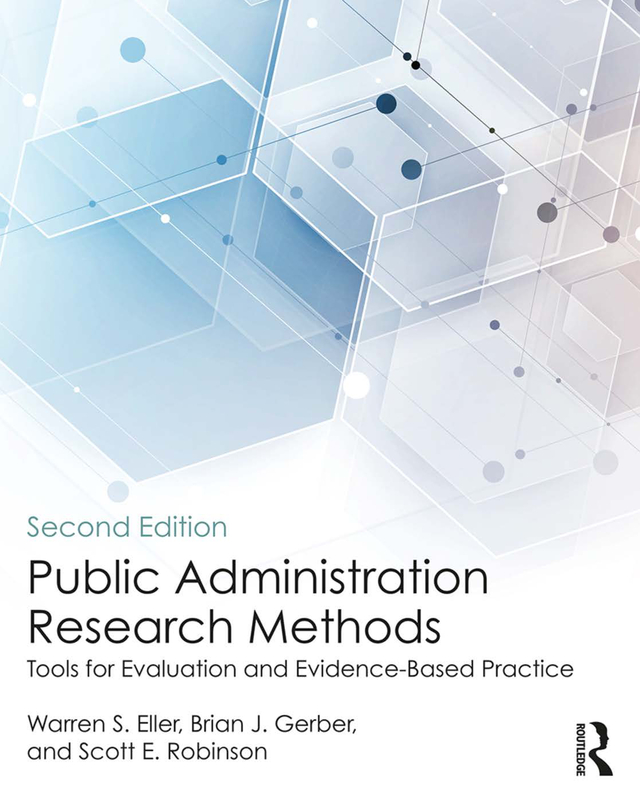
Public Administration Research Methods The best decisions made by public managers are based not on instinct, but on an informed understanding of what’s happening on the ground. Policy may be directed by ideology, but it must also be founded on reality. The challenge of making the right decisions as a public manager is often, therefore, based on the need for rigorous, actionable research. Now in a thoughtfully revised second edition, this textbook shows students of Public Administration exactly how to use both qualitative and quantitative research techniques to give them the best chance to make the right decisions. Uniquely, Eller, Gerber, and Robinson present research methodologies through a series of real-life case studies, with each chapter exploring situations where a public manager can use research to answer specific questions, demonstrating how that research can inform future policy. Taking readers through the key concepts, from research design and sampling to interviews, survey data, and more statistical-based approaches, this new edition provides a complete guide to using research in the public and voluntary sectors. New to this edition: To better orient the student, the second edition is thematically arranged. Five sections, each with a short essay, provide not only previews of the content of each section, but more importantly guide the reader through how the concepts and techniques covered relate to real-world use and application. A new chapter on applied quantitative analyses has been added to offer coverage of several commonly-used and valuable analytic techniques for decision making for policy and management: benefit-cost analysis, risk assessment, and forecasting. The second edition is accompanied by online materials containing suggested course plans and sample syllabi, PowerPoint lecture slides, and student support materials to illustrate the application of key concepts and analytic techniques. Each chapter also includes discussion questions, class exercises, end of chapter review questions, and key vocabulary to provide students with a range of further tools to apply research principles to practical situations. POLITICAL SCIENCE,Public Affairs & Administration

Public Service Ethics Ethics—in all its exemplary and exhausting forms—matters. It deals with the most gripping question in public life: "What is the right thing to do?" Now in a thoroughly revised second edition, Public Service Ethics: Individual and Institutional Responsibilities introduces readers to this personally relevant and professionally challenging field of study. No matter the topic—the necessity of ethics, intriguing human behavior experiments, the role of ethics codes, whistleblowing incidents, corruption exposés, and the grandeur and decay of morality—there is no shortage of controversy. The book enables readers to: appreciate why ethics is essential to leadership; understand and apply moral development theory at the individual and organizational levels of analysis; differentiate between ethical problems and ethical dilemmas, and design creative ways to deal with them; develop abilities to use moral imagination and ethical reasoning—to appraise, argue, and defend an ethical position, and cultivate individual and institutional initiatives to improve ethical climate and infrastructure. Authors James Bowman and Jonathan West capture reader interest by featuring learning objectives, skill-building material, discussion questions, and exercises in each chapter. The authors’ narrative is user-friendly and accessible, highlighting dilemmas and challenging readers to "own" the book by annotating the pages with one’s own ideas and insights, then interacting with others in a live or virtual classroom to stretch one’s thinking about the management of ethics and ethics of management. The ultimate goal is to bolster students’ confidence and prepare them for the ethical problems they will face in the future, equipping them with the conceptual frameworks and context to approach thorny questions and behave ethically. POLITICAL SCIENCE,Public Affairs & Administration

Government for the Future In recognition of its 20 th anniversary, The IBM Center for the Business of Government offers a retrospective of the most significant changes in government management during that period and looks forward over the next 20 years to offer alternative scenarios as to what government management might look like by the year 2040. Part I will discuss significant management improvements in the federal government over the past 20 years, based in part on a crowdsourced survey of knowledgeable government officials and public administration experts in the field. It will draw on themes and topics examined in the 350 IBM Center reports published over the past two decades. Part II will outline alternative scenarios of how government might change over the coming 20 years. The scenarios will be developed based on a series of envisioning sessions which are bringing together practitioners and academics to examine the future. The scenarios will be supplemented with short essays on various topics. Part II will also include essays by winners of the Center’s Challenge Grant competition. Challenge Grant winners will be awarded grants to identify futuristic visions of government in 2040. Contributions by Mark A. Abramson, David A. Bray, Daniel J. Chenok, Lee Feldman, Lora Frecks, Hollie Russon Gilman, Lori Gordon, John M. Kamensky, Michael J. Keegan, W. Henry Lambright, Tad McGalliard, Shelley H. Metzenbaum, Marc Ott, Sukumar Rao, and Darrell M. West. POLITICAL SCIENCE,Public Affairs & Administration
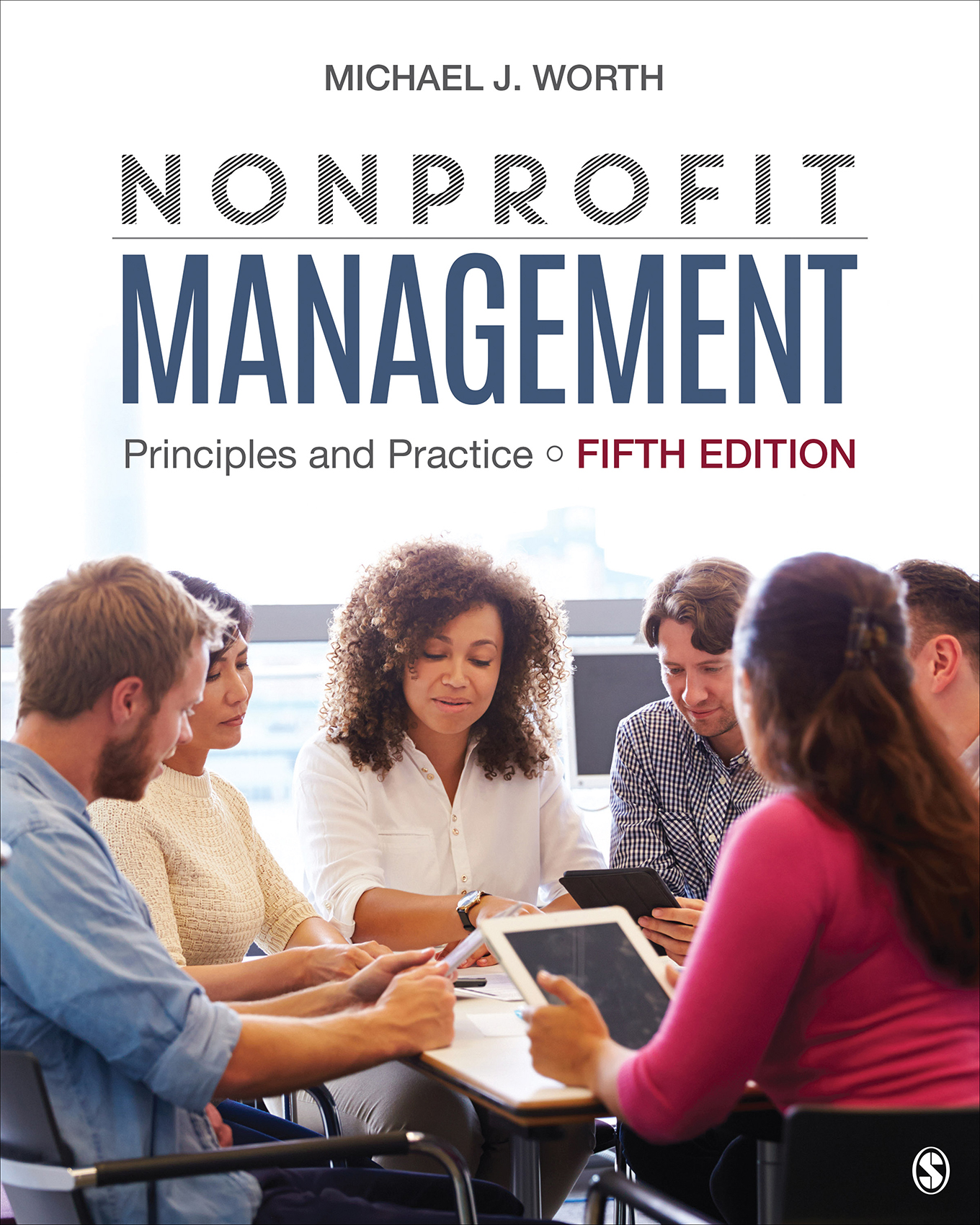
Nonprofit Management Michael J. Worth’s student-friendly best-seller, Nonprofit Management: Principles and Practice, Fifth Edition, provides a broad, insightful overview of key topics affecting governance and management of nonprofit organizations. Worth covers the scope and structure of the nonprofit sector, leadership of nonprofits, managing the nonprofit organization, fundraising, earned income strategies, financial management, nonprofit lobbying and advocacy, managing international and global organizations, and social entrepreneurship. Written specifically for students, this applied text balances research, theory, and practitioner literature with current cases, timely examples, and the most recent data available. New to the Fifth Edition New cases related to accountability and governance highlight new approaches to recent controversies and risks to nonprofits. Cases include the Wounded Warriors Project, Sweet Briar College, 4-H, Housing First, the Chan-Zuckerberg Initiative, the National Audubon Society, and an expanded study of governance issues at the Hershey Trust. Expanded discussions of risk management offer new insights on developing strategy, building capacity, and managing risk. New social networks and social media content provides students with practical strategies for using social media when fundraising and marketing. A new comprehensive case on the Girl Scouts of the USA recounts reforms undertaken by this iconic organization and current challenges it faces. The chapter on financial management has been substantially revised to reflect new requirements for nonprofit financial statements issued by the Financial Accounting Standards Board in 2016, as well as an expanded discussion of audits. An updated chapter on fundraising includes information on the Tax Cuts and Jobs Act passed in December 2017, which has implications for charitable giving. New references at the end of every chapter guide readers to relevant cases in the Appendix, making it easy for instructors to incorporate the cases into classroom discussions. POLITICAL SCIENCE,Public Affairs & Administration

Reforming the Public Sector Many countries are still struggling to adapt to the broad and unexpected effects of modernization initiatives. As changes take shape, governments are challenged to explore new reforms. The public sector is now characterized by profound transformation across the globe, with ramifications that are yet to be interpreted. To convert this transformation into an ongoing state of improvement, policymakers and civil service leaders must learn to implement and evaluate change. This book is an important contribution to that end. Reforming the Public Sector presents comparative perspectives of government reform and innovation, discussing three decades of reform in public sector strategic management across nations. The contributors examine specific reform-related issues including the uses and abuses of public sector transparency, the "Audit Explosion," and the relationship between public service motivation and job satisfaction in Europe. This volume will greatly aid practitioners and policymakers to better understand the principles underpinning ongoing reforms in the public sector. Giovanni Tria, Giovanni Valotti, and their cohorts offer a scientific understanding of the main issues at stake in this arduous process. They place the approach to public administration reform in a broad international context and identify a road map for public management. Contributors include: Michael Barzelay, Nicola Bellé, Andrea Bonomi Savignon, Geert Bouckaert, Luca Brusati, Paola Cantarelli, Denita Cepiku, Francesco Cerase, Luigi Corvo, Maria Cucciniello, Isabell Egger-Peitler, Paolo Fedele, Gerhard Hammerschmid, Mario Ianniello, Elaine Ciulla Kamarck, Irvine Lapsley, Peter Leisink, Mariannunziata Liguori, Renate Meyer, Greta Nasi, James L. Perry, Christopher Pollitt, Adrian Ritz, Raffaella Saporito, MariaFrancesca Sicilia, Ileana Steccolini, Bram Steijn, Wouter Vandenabeele, and Montgomery Van Wart. POLITICAL SCIENCE,Public Affairs & Administration
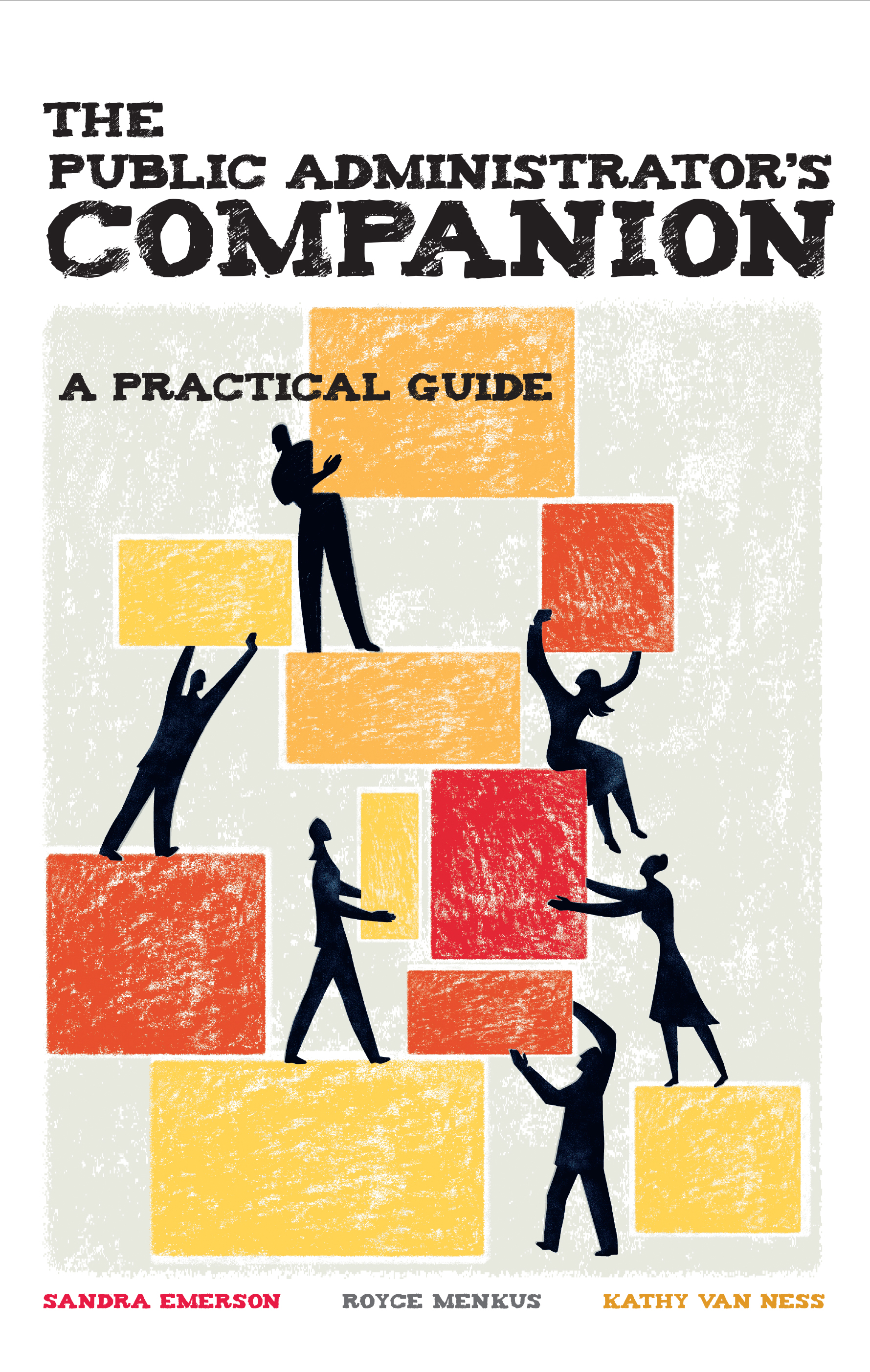
The Public Administrator's Companion This guide provides students will all the information they need to successfully make the transition to becoming a practicing Public Administrator. POLITICAL SCIENCE,Public Affairs & Administration
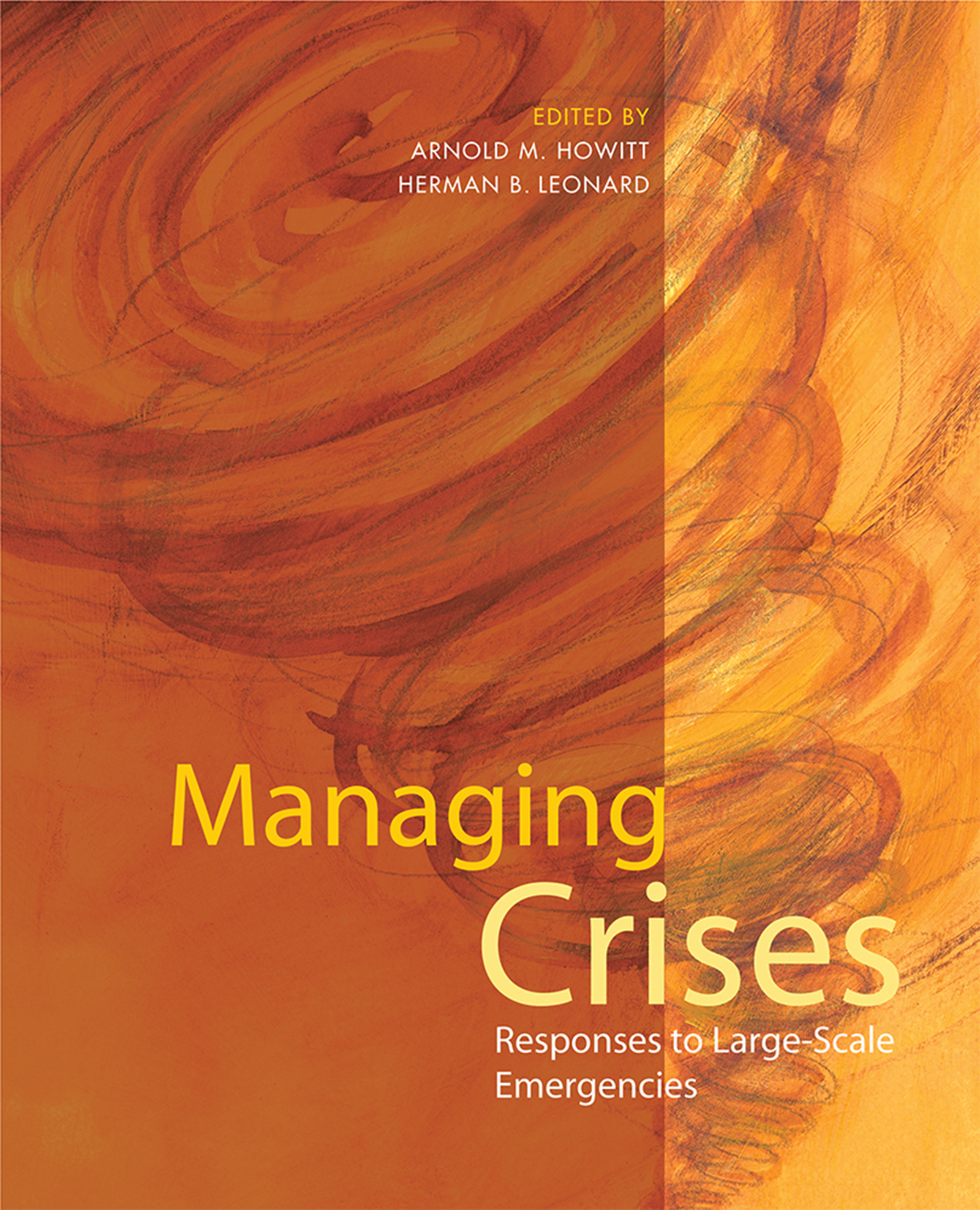
Managing Crises 236384 POLITICAL SCIENCE,Public Affairs & Administration

Managing Local Government Managing Local Government: An Essential Guide for Municipal and County Managers offers a practical introduction to the changing structure, forms, and functions of local governments. Taking a metropolitan management perspective, authors Kimberly Nelson and Carl W. Stenberg explain U.S. local government within historical context and provide strategies for effective local government management and problem solving. Real-life scenarios and contemporary issues illustrate the organization and networks of local governments; the roles, responsibilities, and relationships of city and county managers; and the dynamics of the intergovernmental system. Case studies and discussion questions in each chapter encourage critical analysis of the challenges of collaborative governance. Unlike other books on the market, this text’s combined approach of theory and practice encourages students to enter municipal and county management careers and equips them with tools to be successful from day one. POLITICAL SCIENCE,Public Affairs & Administration
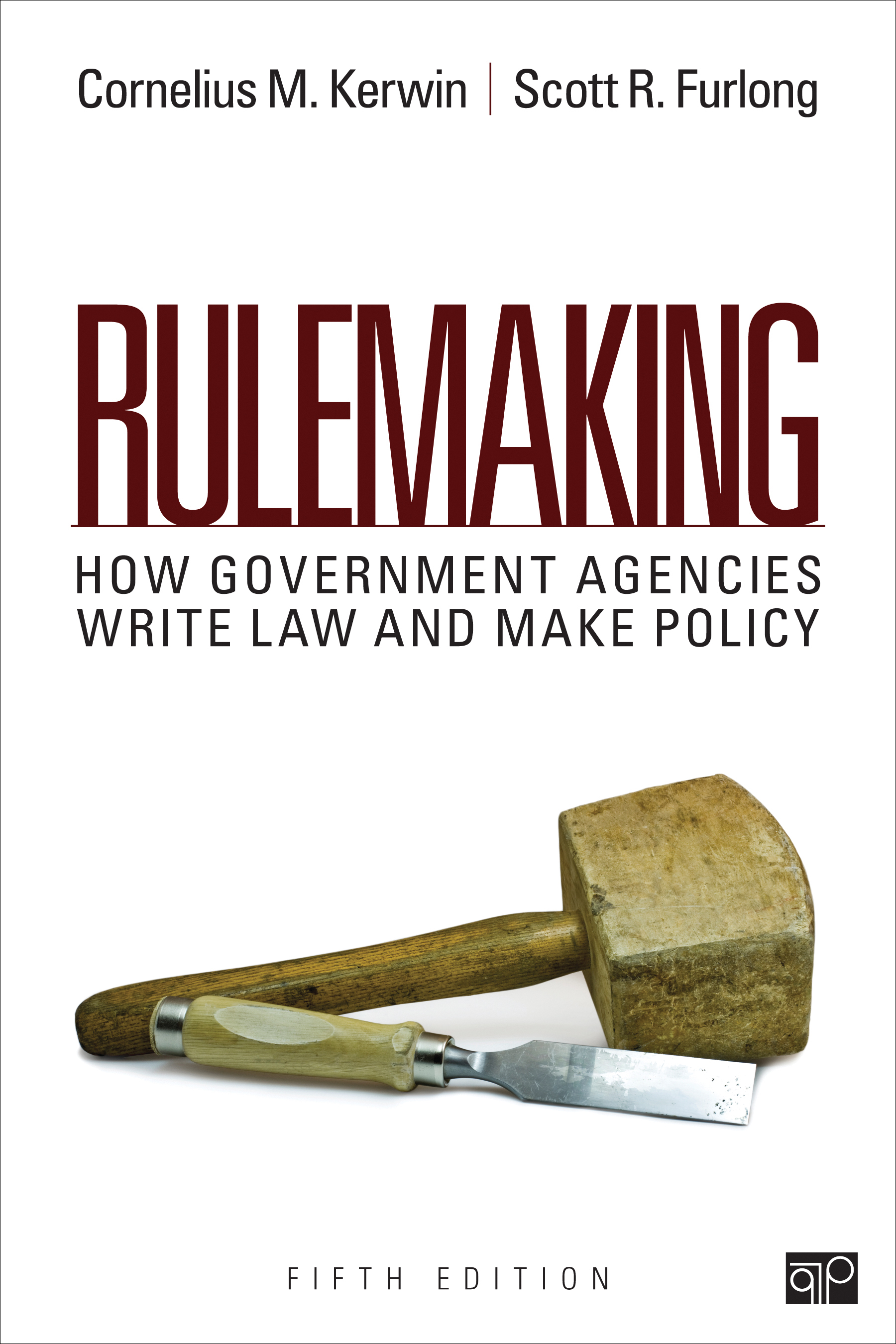
Rulemaking In this thought-provoking new edition of their highly regarded text, authors Cornelius M. Kerwin and Scott R. Furlong help you grasp the dynamics of today’s American politics by showing you how rulemaking remains an elemental part of our government system. Rulemaking, Fifth Edition, brings concepts to life with the inclusion of new data, a fresh analysis of interest group participation, and new coverage of the Trump administration’s actions from executive orders and key personnel to agencies’ responses to changes. An invaluable and accessible guide to an intensely political process, this much-anticipated edition contains the most current scholarship on a crucial yet understudied subject. New to the Fifth Edition New scholarship from the past five to six years provides you with the latest research and analysis in rulemaking. Updated information on the Obama administration and the beginning of the Trump Administration puts rulemaking in context and demonstrates how different administrations use this tool. New tables and charts reflect the most recent data available to better illustrate the trends and patterns of rulemaking. POLITICAL SCIENCE,Public Affairs & Administration
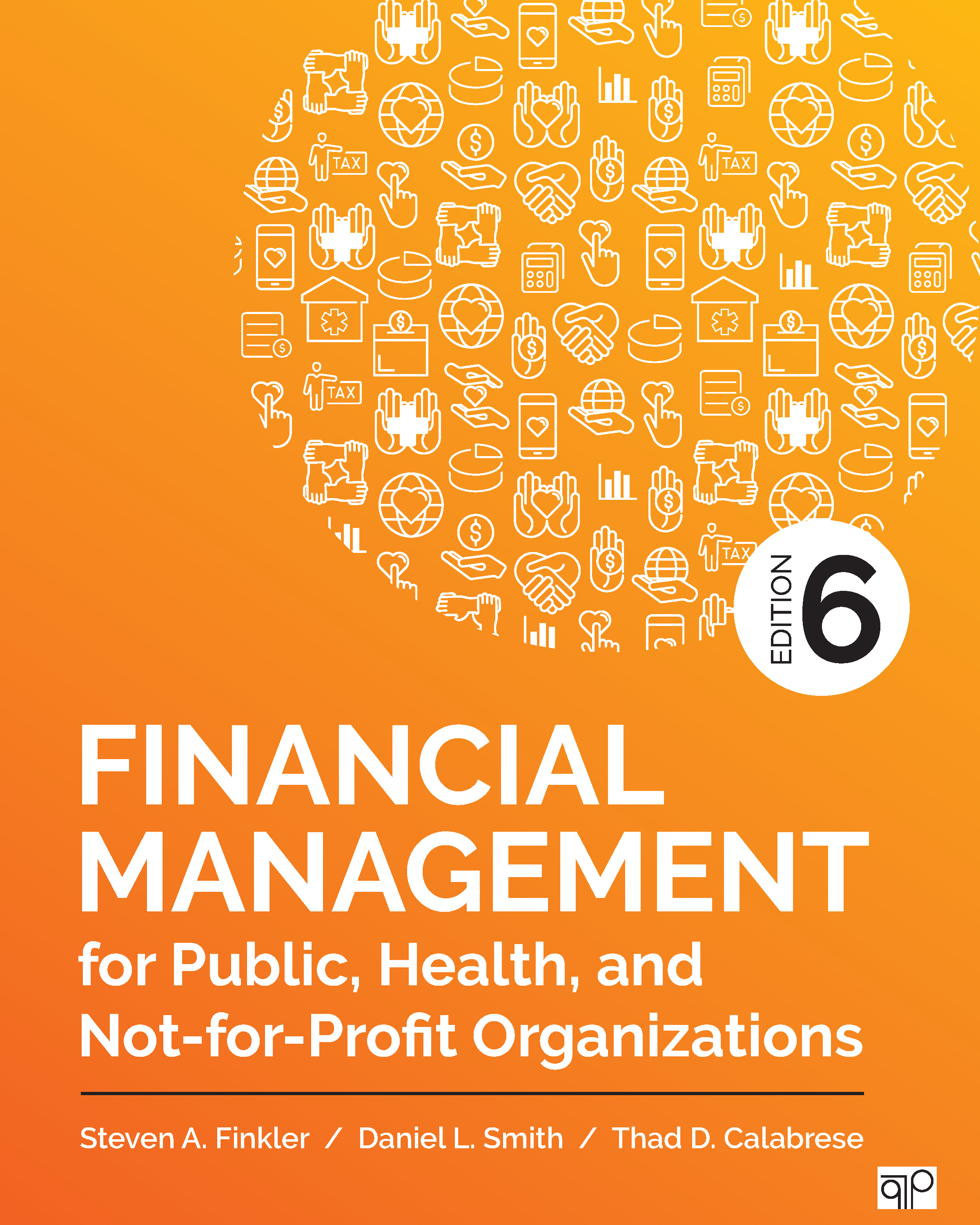
Financial Management for Public, Health, and Not-for-Profit Organizations Reflecting recent changes in accounting standards, this Sixth Edition of Financial Management for Public, Health, and Not-for-Profit Organizations, by Steven A. Finkler, Daniel L. Smith, and Thad D. Calabrese, provides a comprehensive yet practical introduction to the financial decision-making and management skills required of students and practitioners in the public, health, and not-for-profit sectors. Assuming that you have no prior training in financial management, the authors artfully combine the principles, theory, and analytics of accounting and finance. In every chapter, a wide range of exercises, case studies, and problems help you develop strong financial assessment and judgment proficiencies while reinforcing the essential mechanics of accounting. POLITICAL SCIENCE,Public Affairs & Administration
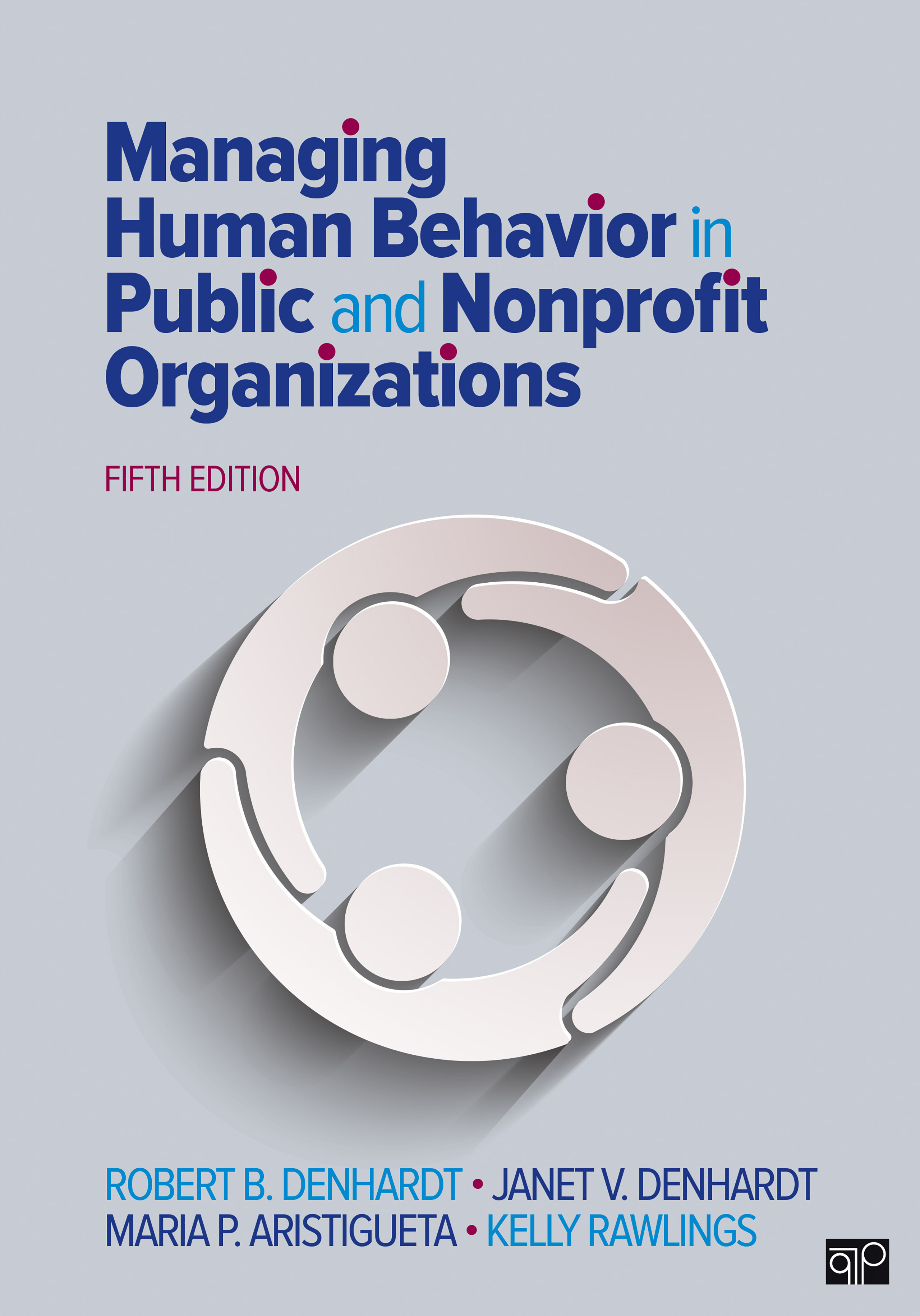
Managing Human Behavior in Public and Nonprofit Organizations Managing Human Behavior in Public and Nonprofit Organizations, Fifth Edition is an established core text designed to help you develop your leadership and management skills. Bestselling authors Denhardt, Denhardt, Aristigueta, and Rawlings cover important topics such as stress, decision-making, motivation, leadership, teams, communication, and change. Cases, self-assessment exercises, and numerous examples provide you with the opportunity to apply concepts and theories discussed in the chapter. Focusing exclusively on organizational behavior in both public and nonprofit organizations, this text is a must-read for students in public administration programs. New to the Fifth Edition: Increased attention to issues related to nonprofit organizations helps you develop a better understanding of the differences and similarities in public and nonprofit organizations, as well as the way they interact with one another and with the private sector. Broadened coverage of issues related to ethics and diversity offers you a broader perspective on important issues to consider, such as the examination of implicit and explicit bias, generational differences, and power and privilege. Additional discussions of collaboration, inclusion, and participation, both within the organization and with external constituencies, show you the value rationale for engagement and its practical effects. Revised and updated information on emerging technology illustrates to you how an increasingly digital, connected, and networked environment affects our ability to manage public and nonprofit organizations. New cases, examples, self-assessments, and exercises cover recent developments in research and practice to offer relevant ways for you to practice and improve your management skills. POLITICAL SCIENCE,Public Affairs & Administration
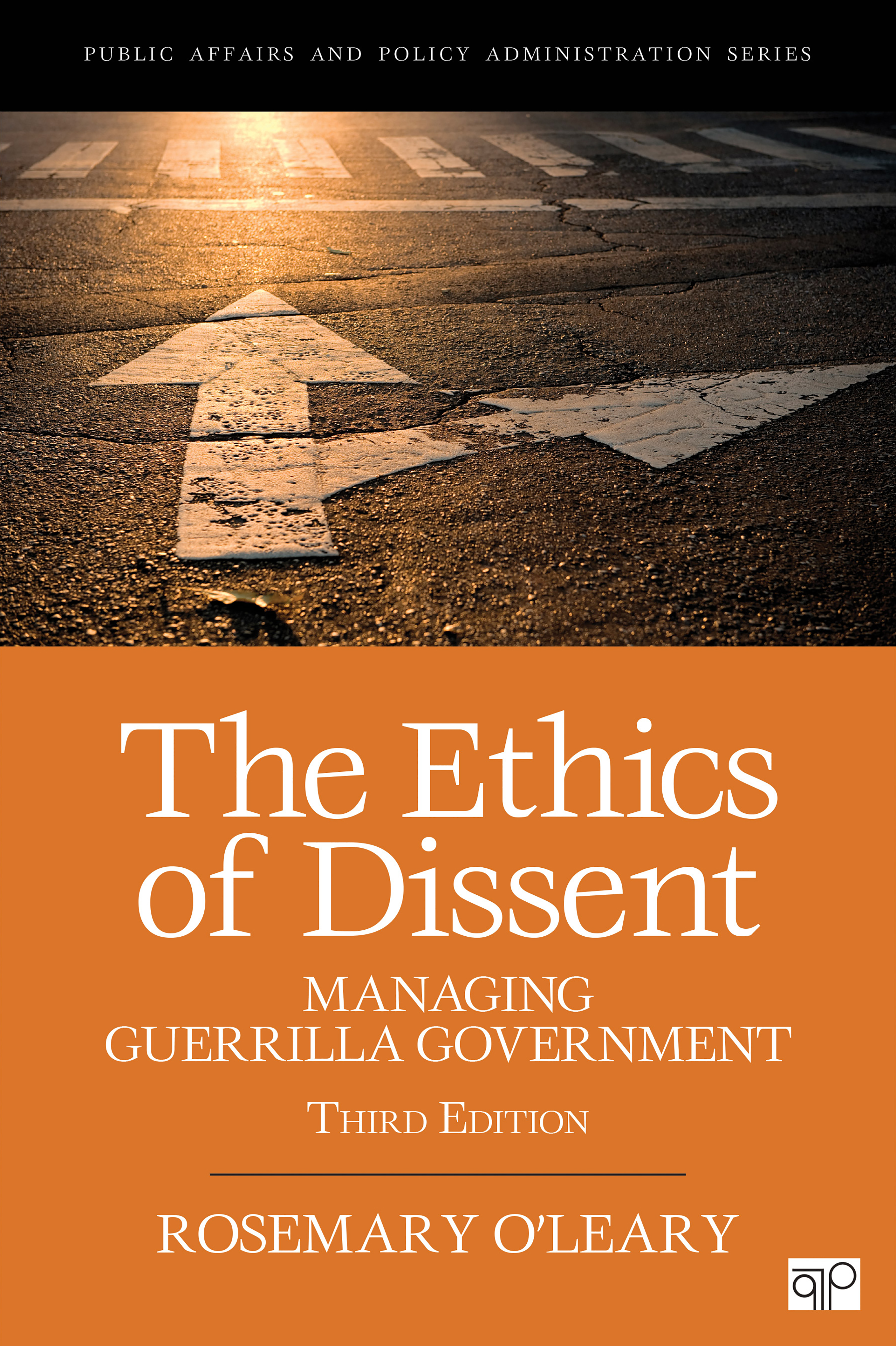
The Ethics of Dissent From “constructive contributorsâ€" to “deviant destroyers,†government guerrillas work clandestinely against the best wishes of their superiors. These public servants are dissatisfied with the actions of the organizations for which they work, but often choose not to go public with their concerns. In her Third Edition of The Ethics of Dissent, Rosemary O’Leary shows that the majority of guerrilla government cases are the manifestation of inevitable tensions between bureaucracy and democracy, which yield immense ethical and organizational challenges that all public managers must learn to navigate. POLITICAL SCIENCE,Public Affairs & Administration
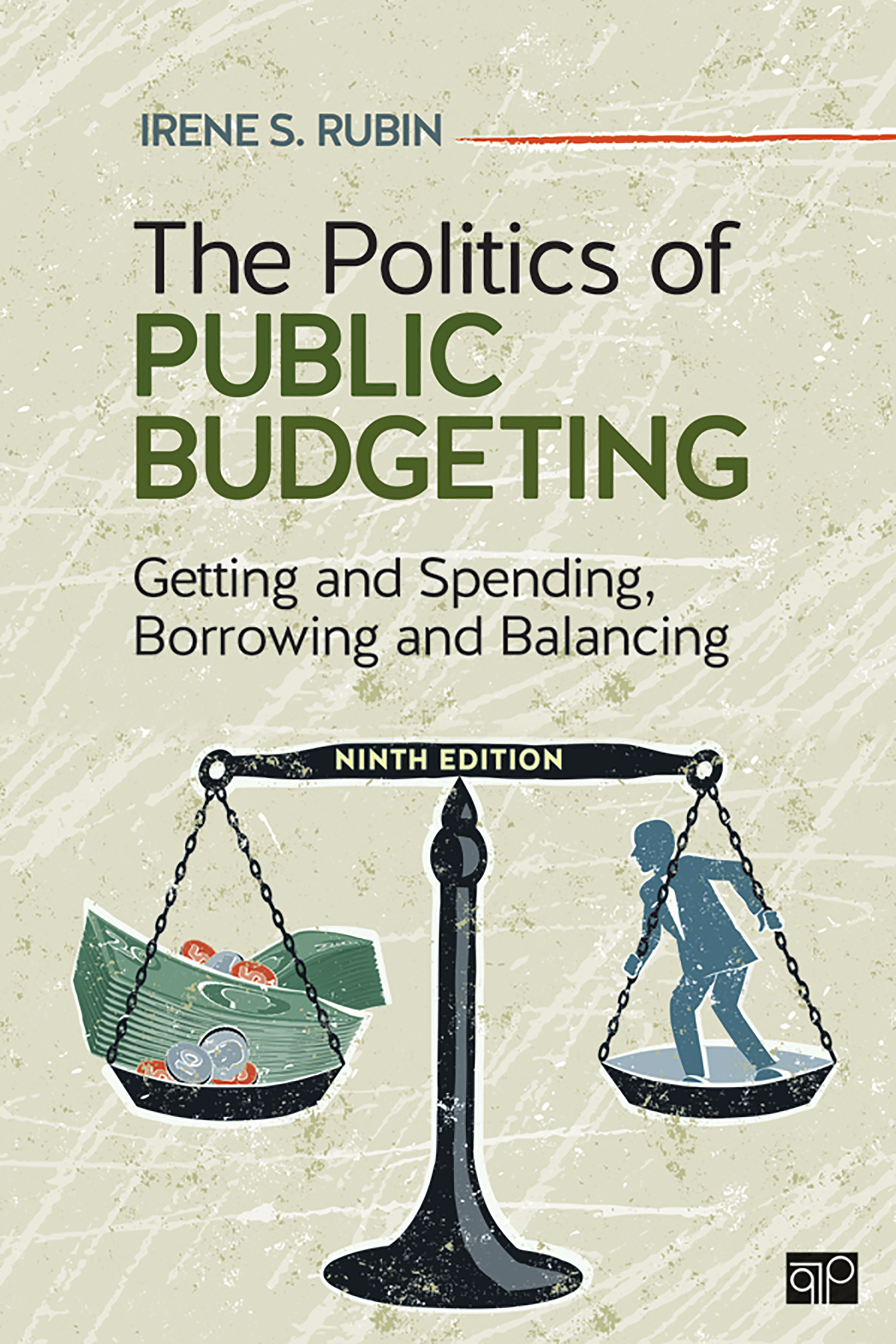
The Politics of Public Budgeting Using a “power struggles†theme to examine the dynamics of budgeting, Rubin’s classic text shines a bright light on the political jockeying between interest groups, parties, officials, policymakers, and the public. Expert at explaining budgeting changes over time, Rubin sets issues like the federal deficit and health care expenditures in political and comparative context. Analyzing each strand of the decision-making process, Rubin shows the extraordinary coordination involved in passing a budget and achieving accountability. POLITICAL SCIENCE,Public Affairs & Administration
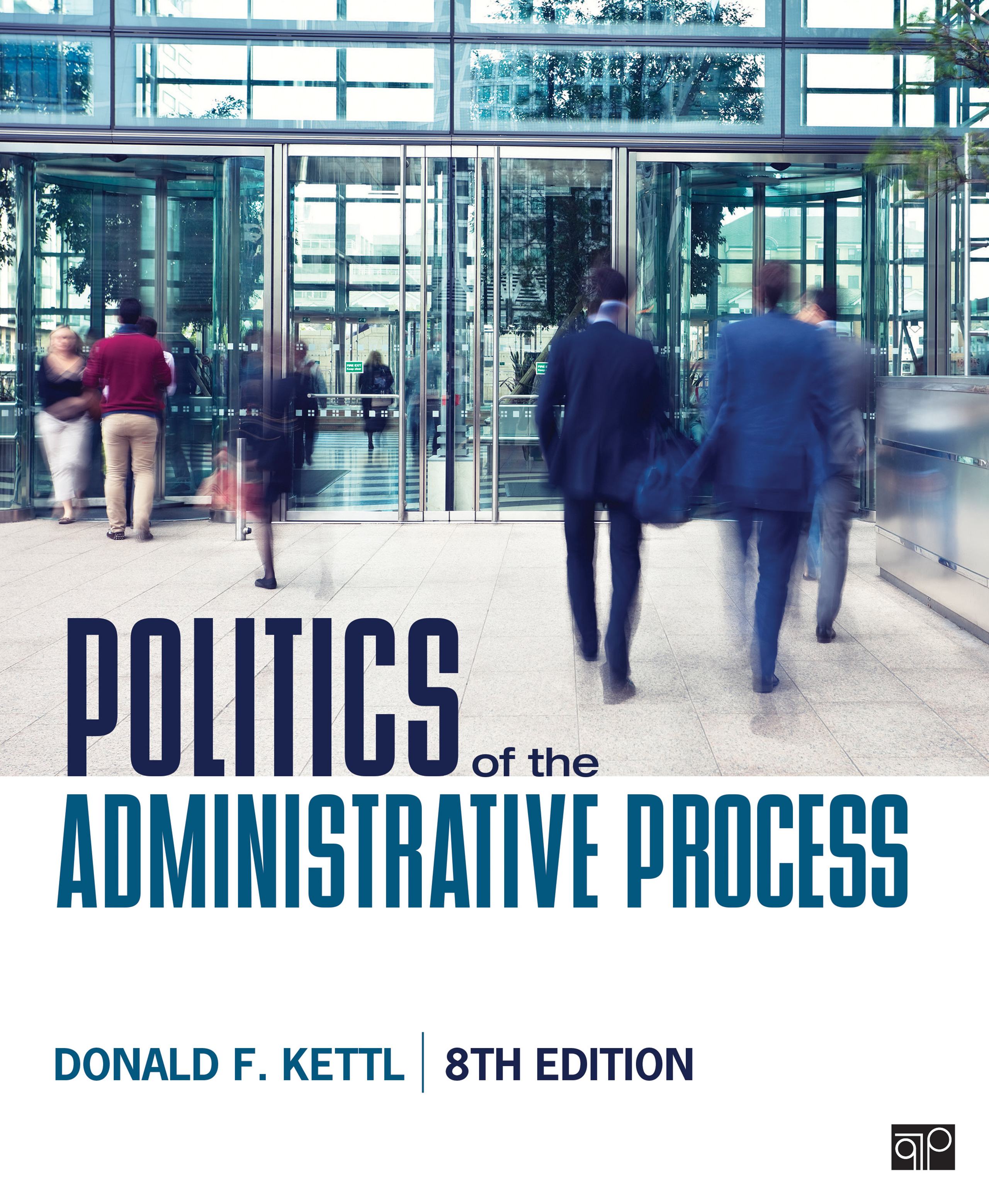
Politics of the Administrative Process Efficient public administration requires a delicate balance—the bureaucracy must be powerful enough to be effective, but also accountable to elected officials and citizens. Donald F. Kettl understands that the push and pull of political forces in a democracy make the functions of bureaucracy contentious, but no less crucial. Politics of the Administrative Process gives students a realistic, relevant, and well-researched view of the field while remaining reader-friendly with engaging vignettes and rich examples. With a unique focus on policymaking and politics, the Eighth Edition continues its strong emphasis on politics, accountability, and performance. POLITICAL SCIENCE,Public Affairs & Administration
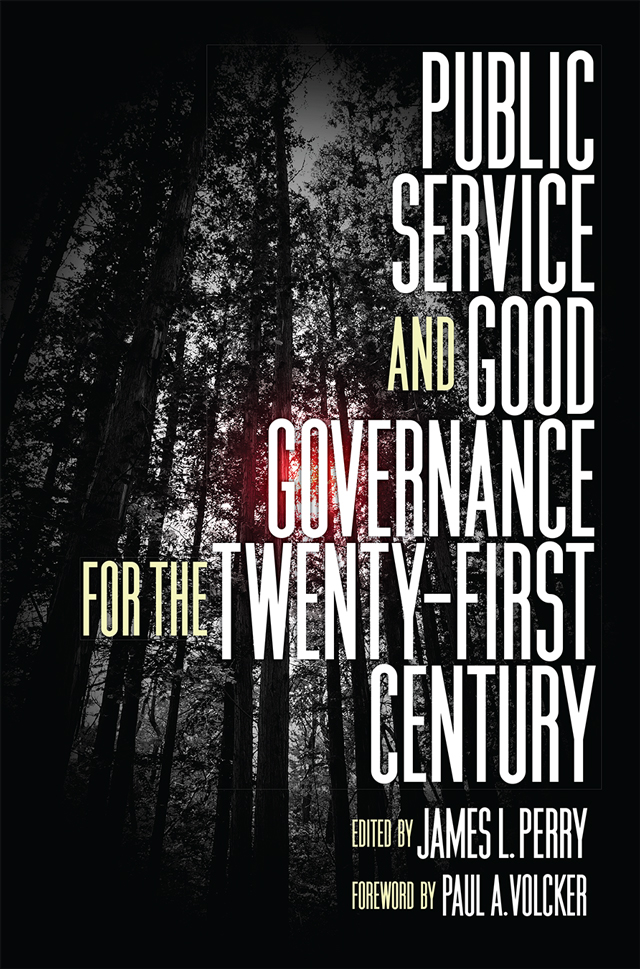
Public Service and Good Governance for the Twenty-First Century Featuring essays from thought leaders in public administration, Public Service and Good Governance for the Twenty-First Century offers insights into the governance challenges facing the nation—from diminished capacity to the failure to meet expectations for reform—and recommendations for how civic institutions and leaders might respond. POLITICAL SCIENCE,Public Affairs & Administration
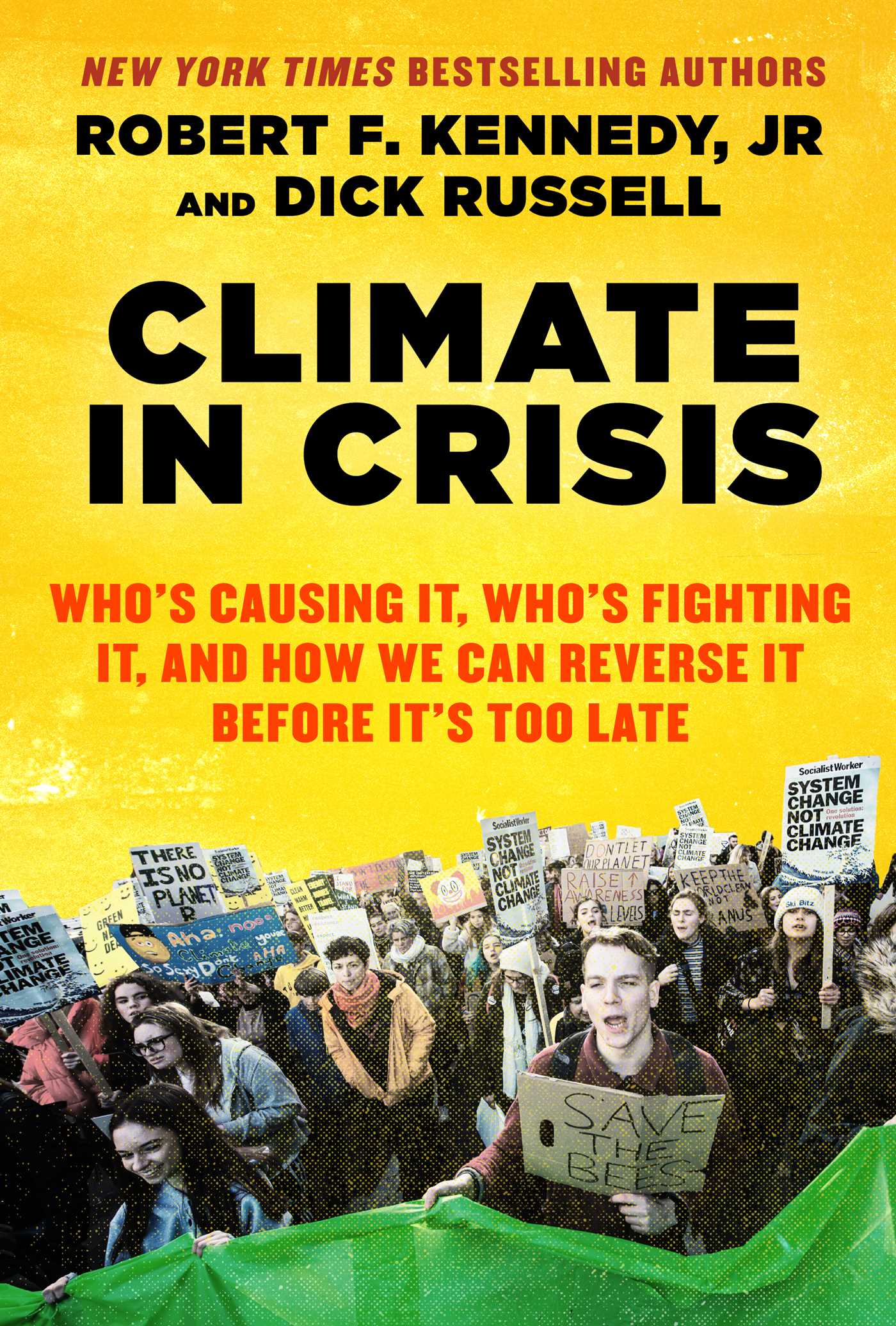
Climate in Crisis The science is overwhelming; the facts are in. The planet is heating up at an alarming rate and the results are everywhere to be seen. Yet, as time runs out, climate progress is blocked by the men who are profiting from the burning of the planet: Energy moguls like the Koch brothers and ExxonMobil CEO Rex Tillerson. Powerful politicians like Senators Mitch McConnell and Jim Inhofe, who receive massive contributions from the oil and coal industries. Most of these men are too intelligent to truly believe that climate change is not a growing crisis. And yet they have put their profits and careers ahead of the health and welfare of the world’s population—and even their own children and grandchildren. How do they explain themselves to their offspring, to the next generations that must deal with the environmental havoc that these men have wreaked? With a new introduction from the authors, Climate in Crisis takes a very personal look at this global crisis, literally bringing it home. POLITICAL SCIENCE,Public Affairs & Administration

Defense Management Reform Pentagon spending has been the target of decades of criticism and reform efforts. Billions of dollars are spent on weapons programs that are later abandoned. State-of-the-art data centers are underutilized and overstaffed. New business systems are built at great expense but fail to meet the needs of their users. Every Secretary of Defense for the last five Administrations has made it a priority to address perceived bloat and inefficiency by making management reform a major priority. The congressional defense committees have been just as active, enacting hundreds of legislative provisions. Yet few of these initiatives produce significant results, and the Pentagon appears to go on, as wasteful as ever. In this book, Peter Levine addresses why, despite a long history of attempted reform, the Pentagon continues to struggle to reduce waste and inefficiency. The heart of Defense Management Reform is three case studies covering civilian personnel, acquisitions, and financial management. Narrated with the insight of an insider, the result is a clear understanding of what went wrong in the past and a set of concrete guidelines to plot a better future. POLITICAL SCIENCE,Public Affairs & Administration

Planning in the Public Domain John Friedmann addresses a central question of Western political theory: how, and to what extent, history can be guided by reason. In this comprehensive treatment of the relation of knowledge to action, which he calls planning, he traces the major intellectual traditions of planning thought and practice. Three of these--social reform, policy analysis, and social learning--are primarily concerned with public management. The fourth, social mobilization, draws on utopianism, anarchism, historical materialism, and other radical thought and looks to the structural transformation of society "from below." After developing a basic vocabulary in Part One, the author proceeds in Part Two to a critical history of each of the four planning traditions. The story begins with the prophetic visions of Saint-Simon and assesses the contributions of such diverse thinkers as Comte, Marx, Dewey, Mannheim, Tugwell, Mumford, Simon, and Habermas. It is carried forward in Part Three by Friedmann's own nontechnocratic, dialectical approach to planning as a method for recovering political community. POLITICAL SCIENCE,Public Affairs & Administration
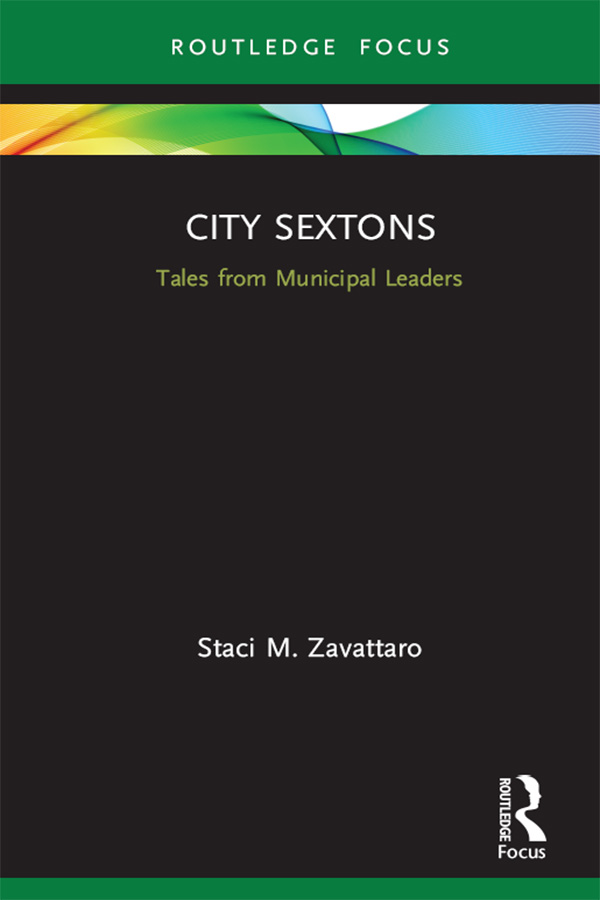
City Sextons City sextons are a dying breed and in this book sextons from throughout the United States share their experiences as a city’s chief death expert. With a view to investigating their role in local governance processes, how they contribute to public engagement in cities, and what are some misconceptions about this role, Staci M. Zavattaro sheds light on unique public servants that are rarely – if at all – discussed in public administration research. Themes discussed include: background stories on each sexton interviewed; vignettes of their most interesting stories that can be used as case studies in public administration practice and teaching; public history functions; self-care strategies they use to deal with the stress of the position. City Sextons: Tales from Municipal Leaders will be of key interest to scholars studying public management, emotional labor, and leadership. POLITICAL SCIENCE,Public Affairs & Administration
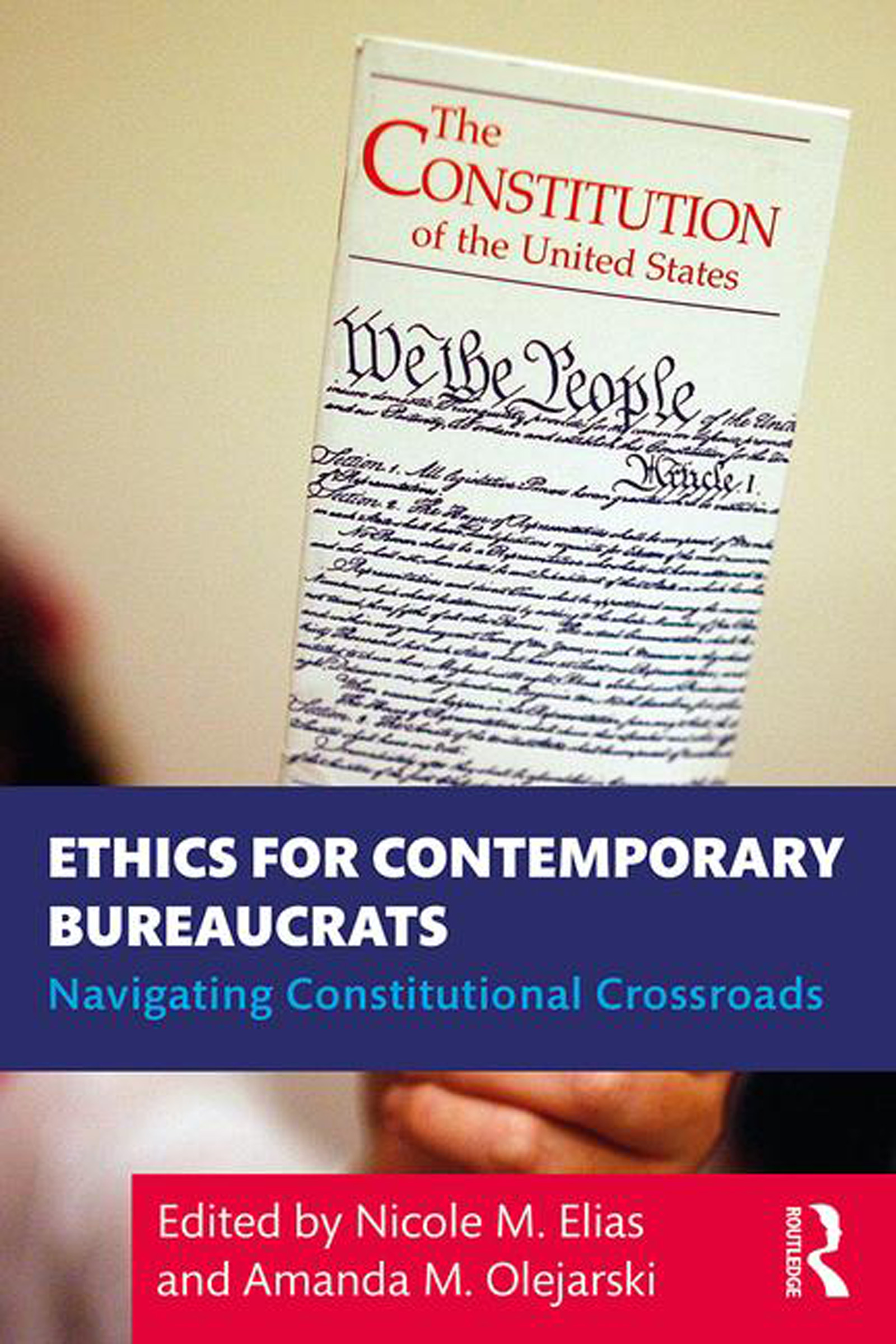
Ethics for Contemporary Bureaucrats In the current United States (U.S.) context, we are facing a constitutional crisis with frequent government shutdowns and new debates surrounding immigration, climate change, budgeting practices, and the balance of power. With competing interests, unclear policy, and inconsistent leadership directives, the question becomes: How do contemporary bureaucrats make sense of this ethically turbulent environment? This collection provides a lens for viewing administrative decision-making and behavior from a constitutional basis, as contemporary bureaucrats navigate uncharted territory. Ethics for Contemporary Bureaucrats is organized around three constitutional values: freedom, property, and social equity. These themes are based on emerging trends in public administration and balanced with traditional ethical models. Each chapter provides an overview of a contemporary ethical issue, identifies key actors, institutions, legal and legislative policy, and offers normative and practical recommendations to address the challenges the issue poses. Rooted in a respected and time-tested intellectual history, this volume speaks to bureaucrats in a modern era of governance. It is ideally suited to educate students, scholars, and public servants on constitutional values and legal precedent as a basis for ethics in the public sector. POLITICAL SCIENCE,Public Affairs & Administration
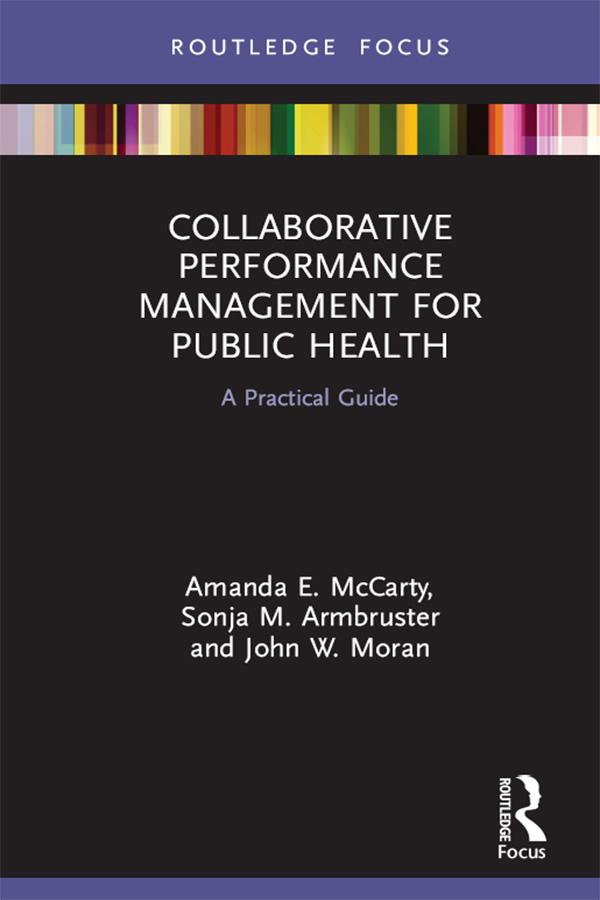
Collaborative Performance Management for Public Health Performance management can be an uncomfortable topic within the discipline of public health. Written by leaders in public health performance management and quality improvement, this book carefully explains what public health performance management is – and makes a strong case for why it is needed to tackle successfully the long-standing health issues plaguing communities and states. Notably, the book eschews the need to invest in technology or to learn a new performance management vocabulary. Rather the authors advocate for more thoughtful use of the resources already available in the organization, relying on public health leadership working in conjunction with well trained staff to manage their own organizational performance. To be broadly accepted within public health, performance management concepts and models have to be framed and populated with public health examples, and this book offers a wealth of practical insights and case studies that may be immediately applied to public health organizations, from assessing an organization’s needs, introducing a performance management system to the organization, developing an agency’s goals and targets, to implementation of sound performance management systems and plans. Collaborative Performance Management for Public Health is required reading for all public health leaders and employees concerned with maximizing the health impact of scarce resources. POLITICAL SCIENCE,Public Affairs & Administration
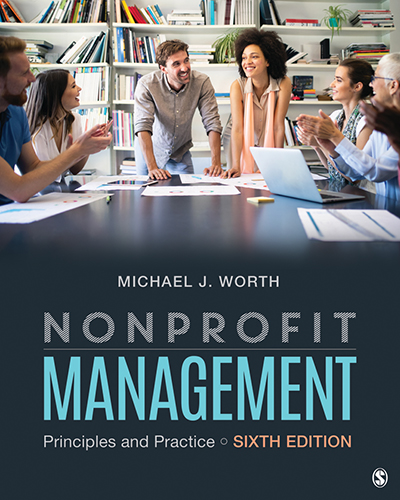
Nonprofit Management Michael J. Worth’s best-seller, Nonprofit Management: Principles and Practice, provides a comprehensive, insightful overview of key topics nonprofit leaders encounter daily. Worth covers both the governance and management of nonprofit organizations—the scope and structure of the nonprofit sector, leadership of nonprofits, management, fundraising, earned income strategies, financial management, lobbying and advocacy, managing international and global organizations, and social entrepreneurship—helping readers understand what they are and how they work. The text balances research, theory, and practitioner literature with current cases and the most recent data available, making it appropriate for undergraduates, graduate students, and nonprofit professionals. The Sixth Edition has been updated to include new material regarding diversity, equality, and inclusion; volunteer stewardship; nonprofit executive transitions; models for pursuing earned income; ethical dilemmas and controversial donors; generational differences in the workplace; and an exploration of the role of nonprofits in advancing social movements. POLITICAL SCIENCE,Public Affairs & Administration
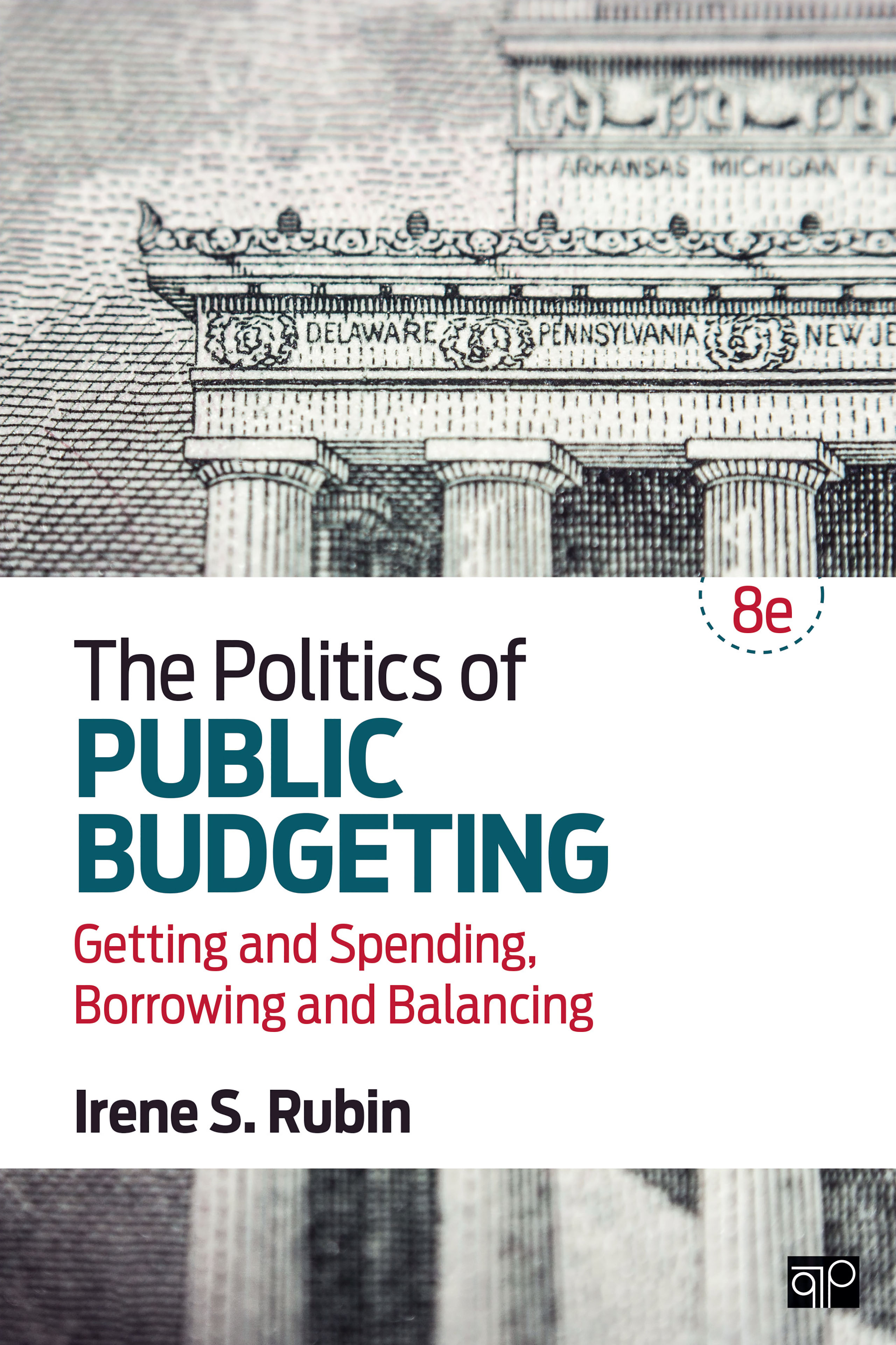
The Politics of Public Budgeting Public budgeting is inherently political. In The Politics of Public Budgeting, author Irene S. Rubin lays out the actors involved–interest groups, public officials, legislators, and the public–and shines a light on how these groups, who each have their own goals, are able to bargain and barter their way to a resolution. The new Eighth Edition examines the budgeting process over time and sets issues like the federal deficit and health care expenditures in political and comparative context. As in previous editions, the book also draws on examples from all levels of government and emphasizes the relationships among them. By carefully analyzing each strand of the decision-making process, Rubin shows the extraordinary cooperation involved in passing a budget and achieving accountability. POLITICAL SCIENCE,Public Affairs & Administration
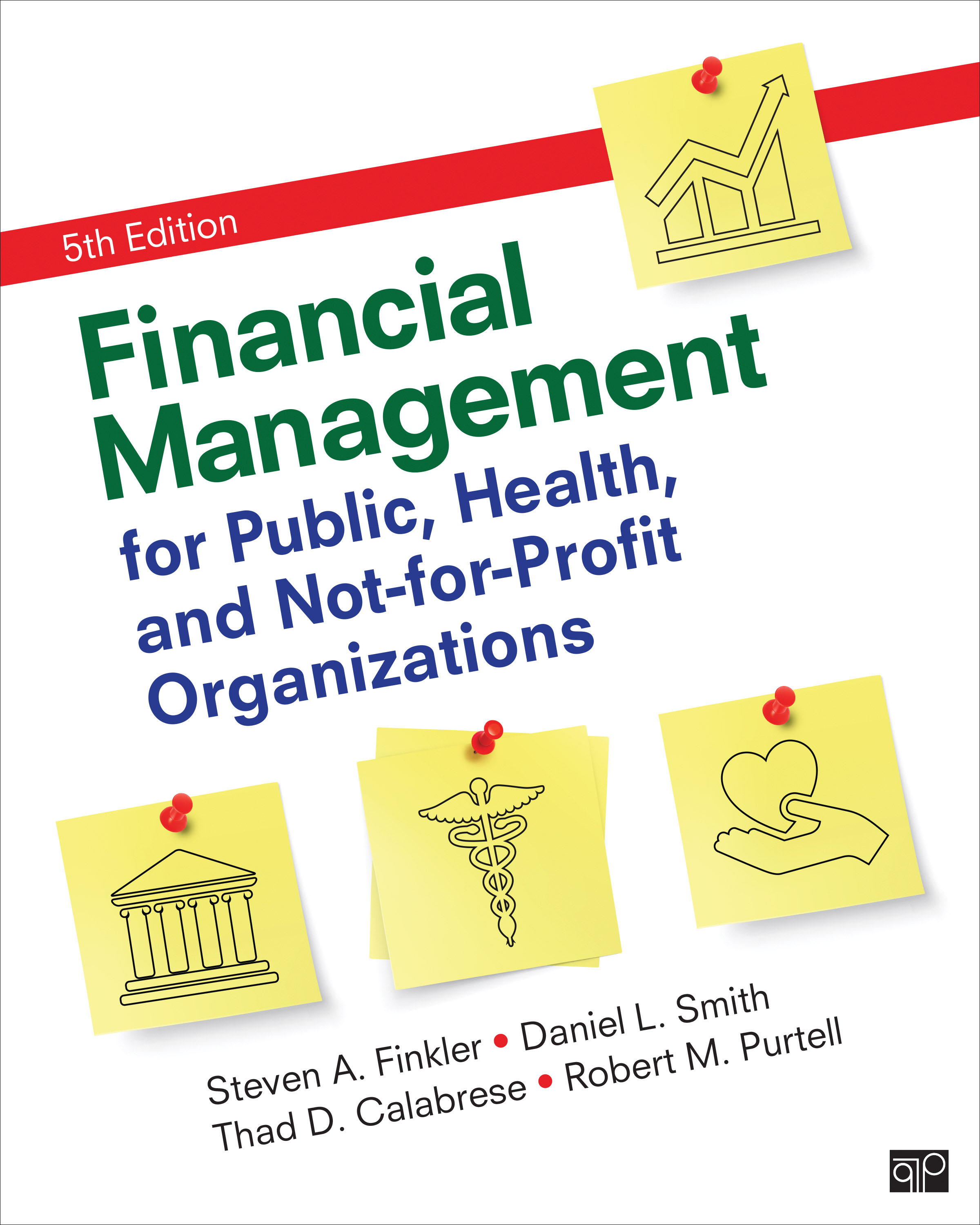
Financial Management for Public, Health, and Not-for-Profit Organizations Now in its Fifth Edition, Financial Management for Public, Health, and Not-for-Profit Organizations is the leading textbook on financial management in the government, health, and not-for-profit sectors providing a comprehensive yet practical introduction to the financial decision-making and management skills required of students and practitioners in the field. Assuming readers have no prior training in financial management, authors Steven A. Finkler, Daniel L. Smith, Thad D. Calabrese, and Robert M. Purtell artfully combine the principles and theory and analytics of accounting and finance. Coverage includes cost analysis, budget preparation, budget and variance analysis, management control, and recording and reporting financial information, with an emphasis on preparing and analyzing financial statements. The authors detail the foundational principles of each of the methods introduced in the book, and through step-by-step equations, figures, and exhibits, they illustrate how to execute financial management in practice. POLITICAL SCIENCE,Public Affairs & Administration
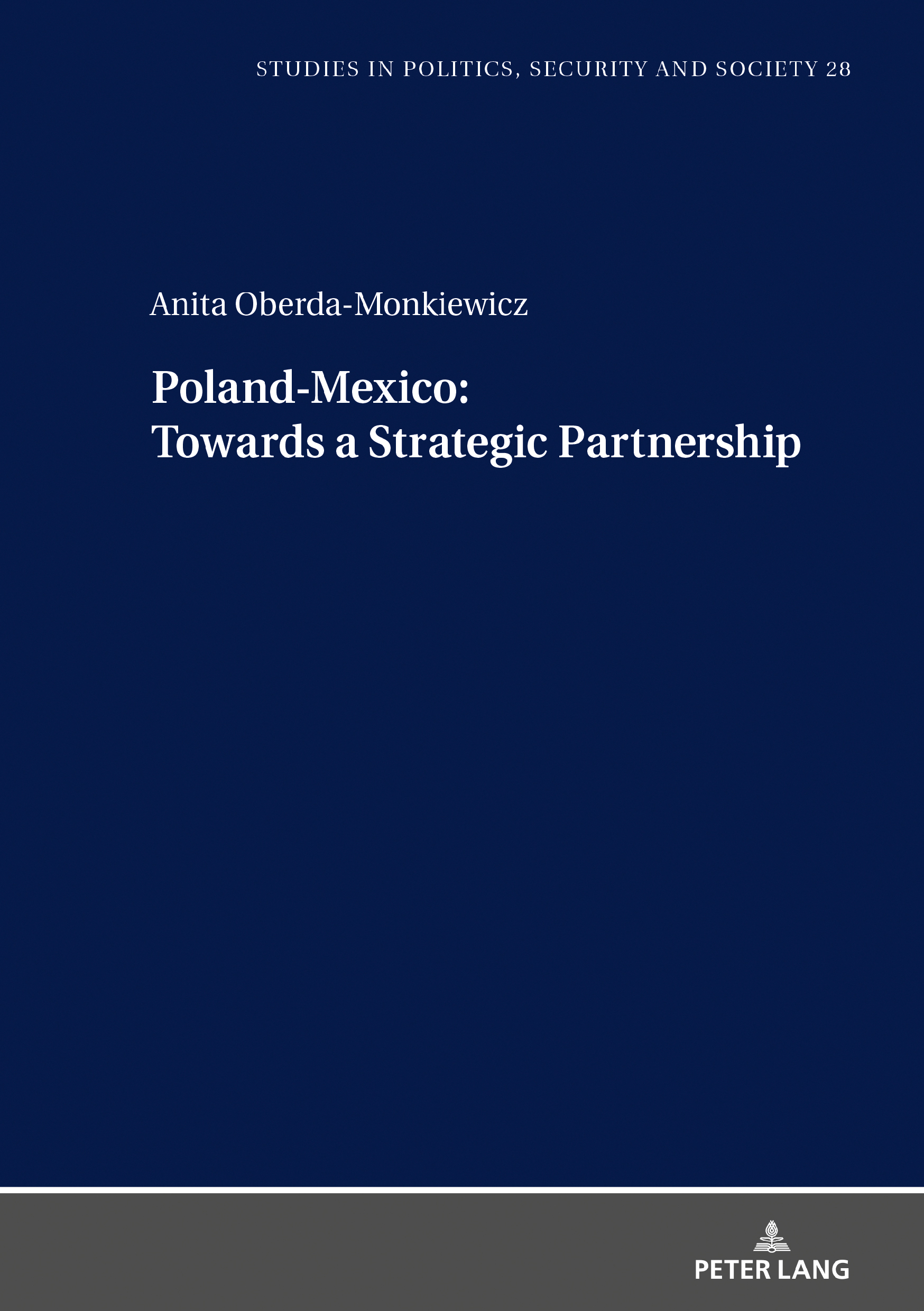
Poland-Mexico towards a Strategic Partnership The book analyzes historical and contemporary relations between Poland and Mexico. It includes their political, economic and cultural dimensions, as well as the role of Polish migration to Mexico. The timeframe of the work is from the begining of first direct contacts between the states till 2017 and the announcement of the strategic partnership POLITICAL SCIENCE,Public Affairs & Administration
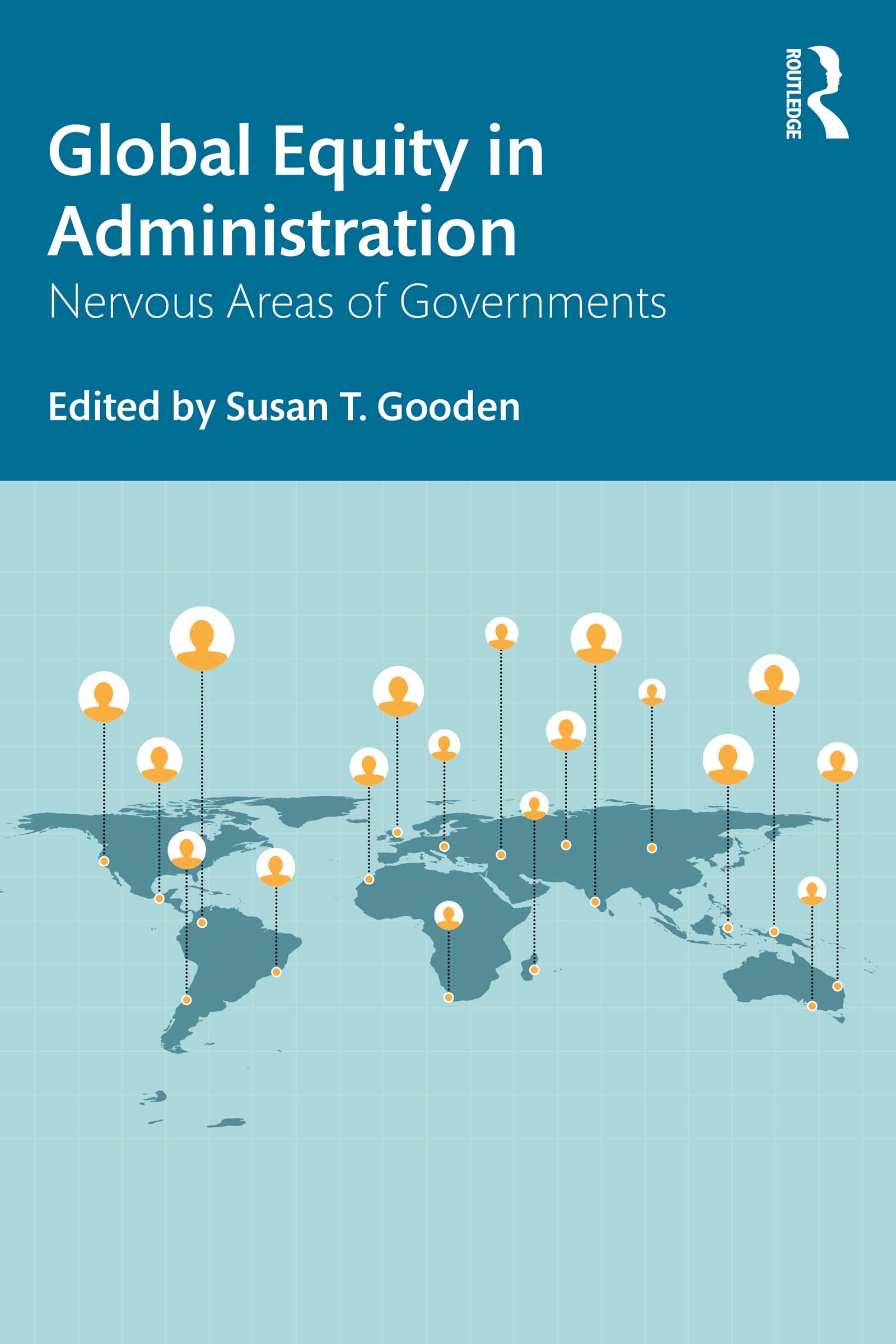
Global Equity in Administration Governments around the world face the challenge of espousing principles of fairness but practicing inequity in their administration. Issues of equity and justice are fundamental concerns of government, and thus to public administrators, who constantly struggle to evaluate a country’s social climate and ensure equity in governance. Such evaluation is unlikely to occur in a serious way, however, if government actors are fundamentally too uncomfortable to directly engage the topic. The result, this book argues, is a context of 'nervousness,' which unless squarely acknowledged and addressed, can become debilitating and thwart progress toward achieving social equity. This volume explores and expands our understanding of the concept of nervousness in the administration of government services around the world, demonstrating the ways in which such an emotional and physical reaction can debilitate government actions that are needed to promote social equity and justice. Each of the chapters in this edited volume focuses on a single country and examines a specific nervous area of government, highlighting important historical and political considerations, as well as specific evidence of promising progress. It considers the complexity of nervous areas of governments around the world, while identifying encouraging approaches and initiatives. Global Equity in Administration is required reading for all practicing and aspiring public servants concerned with fair and equitable provision of public services around the world. POLITICAL SCIENCE,Public Affairs & Administration

Developing and Managing Requests for Proposals in the Public Sector Mastering RFP solicitations is a critical skill required of every public procurement professional. Designed to provide a strategic overview of the skills and traits necessary to fulfill the procurement function, Developing and Managing Requests for Proposals in the Public Sector explores the complex and ever-changing process of competitive negotiations, providing hands-on guidance for practitioners to successfully achieve the best value for both their entity and the taxpayer. While rules, ordinances, policies, practices, and procedures vary among jurisdictions, the book breaks down the basic steps involved in the competitive negotiation process, providing best practice guidance for public procurement professionals to help them navigate the formidable and exacting process successfully, fairly, and with transparency. This book is required reading for every public procurement professional and will be recommended reading for all public procurement courses as well as concentration and certificate programs. POLITICAL SCIENCE,Public Affairs & Administration

Bureaucracy’s Masters and Minions In Bureaucracy’s Masters and Minions the author argues that political control of the bureaucracy from the president and the Congress is largely contingent on an agency’s internal characteristics of workforce composition, workforce responsibilities, and workforce organization. POLITICAL SCIENCE,Public Affairs & Administration

The American Way of Eating The New York Times bestselling work of undercover journalism in the tradition of Barbara Ehrenreich’s Nickel and Dimed that fully investigates our food system to explain what keeps Americans from eating well—and what we can do about it. When award-winning (and working-class) journalist Tracie McMillan saw foodies swooning over $9 organic tomatoes, she couldn’t help but wonder: What about the rest of us? Why do working Americans eat the way we do? And what can we do to change it? To find out, McMillan went undercover in three jobs that feed America, living and eating off her wages in each. Reporting from California fields, a Walmart produce aisle outside of Detroit, and the kitchen of a New York City Applebee’s, McMillan examines the reality of our country’s food industry in this “clear and essential†(The Boston Globe) work of reportage. Chronicling her own experience and that of the Mexican garlic crews, Midwestern produce managers, and Caribbean line cooks with whom she works, McMillan goes beyond the food on her plate to explore the national priorities that put it there. Fearlessly reported and beautifully written, The American Way of Eating goes beyond statistics and culture wars to deliver a book that is fiercely honest, strikingly intelligent, and compulsively readable. In making the simple case that—city or country, rich or poor—everyone wants good food, McMillan guarantees that talking about dinner will never be the same again. POLITICAL SCIENCE,Public Policy,Agriculture & Food Policy (see also SOCIAL SCIENCE,Agriculture & Food)
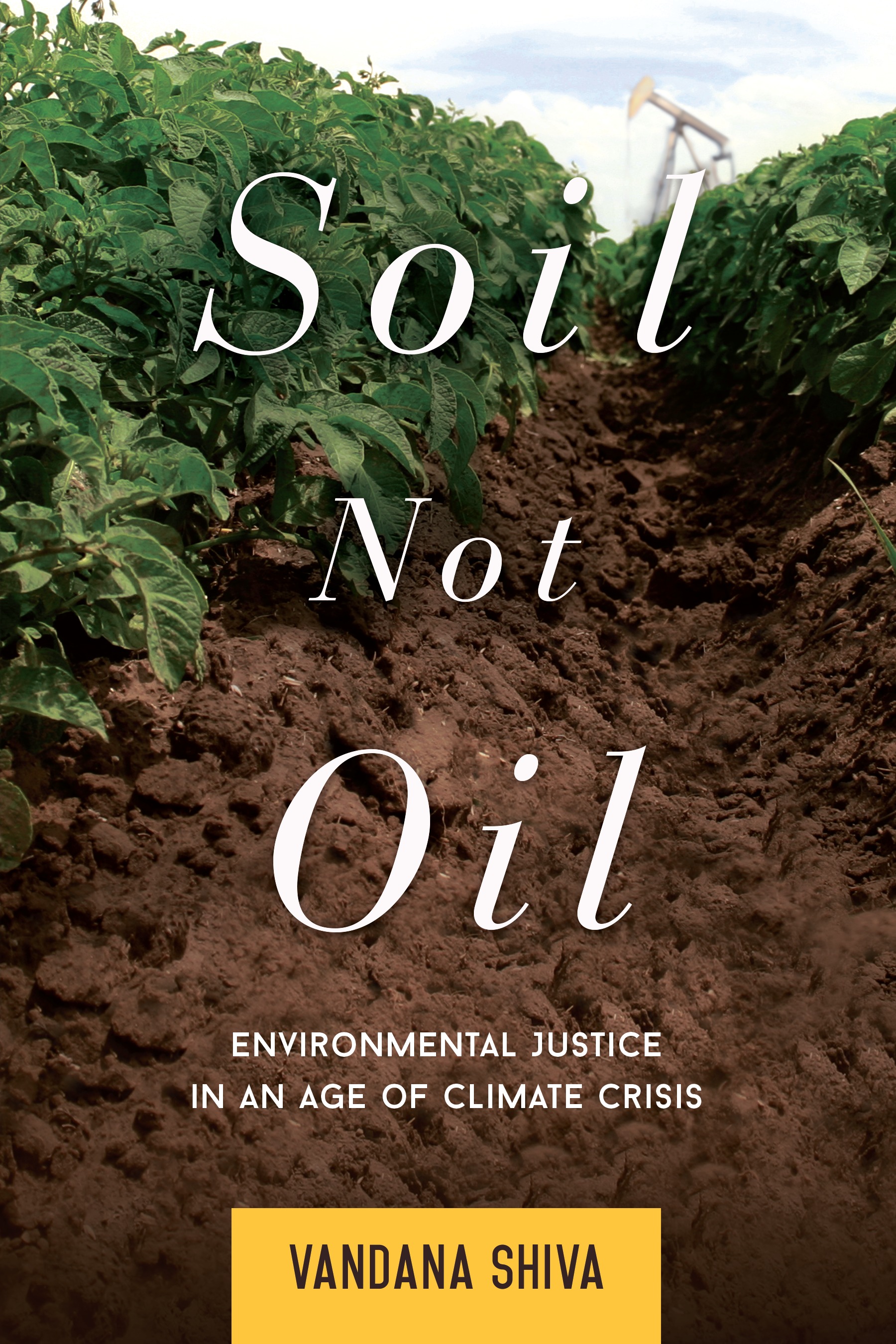
Soil Not Oil In Soil Not Oil, Vandana Shiva explains that a world beyond dependence on fossil fuels and globalization is both possible and necessary. Condemning industrial agriculture as a recipe for ecological and economic disaster, Shiva champions the small, independent farm: their greater productivity, their greater potential for social justice as they put more resources into the hands of the poor, and the biodiversity that is inherent to the traditional farming practiced in small-scale agriculture. What we need most in a time of changing climates and millions who are hungry, she argues, is sustainable, biologically diverse farms that are more resistant to disease, drought, and flood. “The solution to climate change,” she observes, “and the solution to poverty are the same.” Soil Not Oil proposes a solution based on self-organization, sustainability, and community rather than corporate power and profits. POLITICAL SCIENCE,Public Policy,Agriculture & Food Policy (see also SOCIAL SCIENCE,Agriculture & Food)

The Poison Squad A New York Times Notable Book The inspiration for PBS's AMERICAN EXPERIENCE film The Poison Squad. From Pulitzer Prize winner and New York Times-bestselling author Deborah Blum, the dramatic true story of how food was made safe in the United States and the heroes, led by the inimitable Dr. Harvey Washington Wiley, who fought for change By the end of nineteenth century, food was dangerous. Lethal, even. "Milk" might contain formaldehyde, most often used to embalm corpses. Decaying meat was preserved with both salicylic acid, a pharmaceutical chemical, and borax, a compound first identified as a cleaning product. This was not by accident; food manufacturers had rushed to embrace the rise of industrial chemistry, and were knowingly selling harmful products. Unchecked by government regulation, basic safety, or even labelling requirements, they put profit before the health of their customers. By some estimates, in New York City alone, thousands of children were killed by "embalmed milk" every year. Citizens--activists, journalists, scientists, and women's groups--began agitating for change. But even as protective measures were enacted in Europe, American corporations blocked even modest regulations. Then, in 1883, Dr. Harvey Washington Wiley, a chemistry professor from Purdue University, was named chief chemist of the agriculture department, and the agency began methodically investigating food and drink fraud, even conducting shocking human tests on groups of young men who came to be known as, "The Poison Squad." Over the next thirty years, a titanic struggle took place, with the courageous and fascinating Dr. Wiley campaigning indefatigably for food safety and consumer protection. Together with a gallant cast, including the muckraking reporter Upton Sinclair, whose fiction revealed the horrific truth about the Chicago stockyards; Fannie Farmer, then the most famous cookbook author in the country; and Henry J. Heinz, one of the few food producers who actively advocated for pure food, Dr. Wiley changed history. When the landmark 1906 Food and Drug Act was finally passed, it was known across the land, as "Dr. Wiley's Law." Blum brings to life this timeless and hugely satisfying "David and Goliath" tale with righteous verve and style, driving home the moral imperative of confronting corporate greed and government corruption with a bracing clarity, which speaks resoundingly to the enormous social and political challenges we face today. POLITICAL SCIENCE,Public Policy,Agriculture & Food Policy (see also SOCIAL SCIENCE,Agriculture & Food)
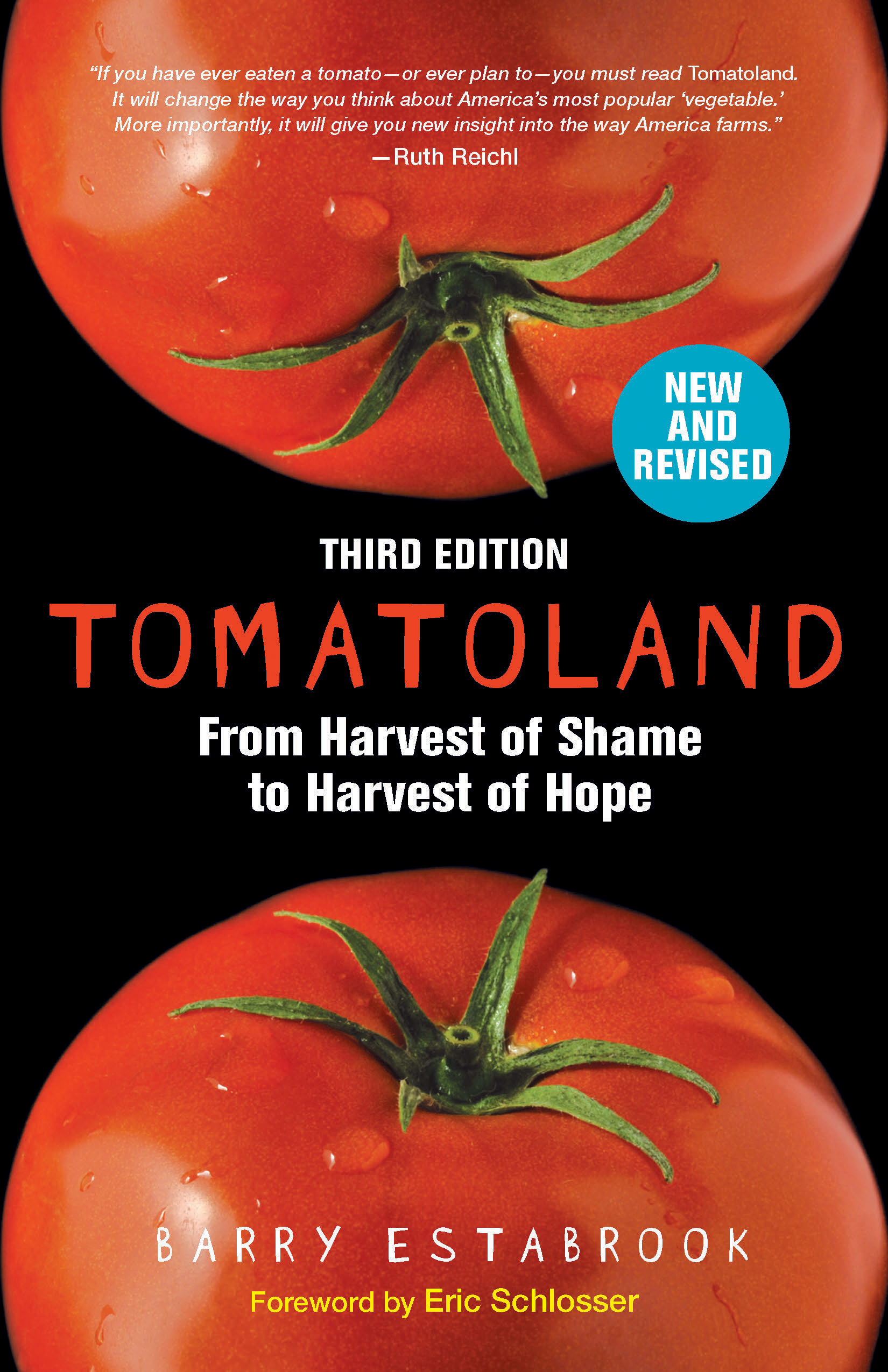
Tomatoland, Third Edition Four entirely new chapters take up where the current edition leaves off to tell the story behind what president Bill Clinton calls “the most astonishing thing politically in the world we’re living in today.†Estabrook reveals how a rag-tag group of migrant tomato pickers in Florida convinced the world’s largest restaurant chains and food retailers to join forces to create a model for labor justice, and then took the necessary steps to make sure that the model really works, not only in Florida, but around the world. The book includes a new foreword by journalist and author Eric Schlosser (Fast Food Nation). POLITICAL SCIENCE,Public Policy,Agriculture & Food Policy (see also SOCIAL SCIENCE,Agriculture & Food)

The Farm Bill The Farm Bill is one of the most important pieces of legislation the American president signs. Negotiated every five to seven years, it has tremendous implications for food production, nutrition assistance, habitat conservation, international trade, and much more. Yet at nearly 1,000 pages, it is difficult to understand for policymakers, let alone citizens. In this primer, Dan Imhoff and Christina Badaracco translate all the "legalease" and political jargon into an accessible, graphics-rich 200 pages. Readers will learn the basic elements of the bill, its origins and history, and perhaps most importantly, the battles that will determine the direction of food policy in the coming years. The authors trace how the legislation has evolved, from its first incarnation during the Great Depression, to today, when America has become the world's leading agricultural powerhouse. They explain the three main components of the bill—farm subsidies, food stamps or SNAP, and conservation programs—as well as how crucial public policies are changing. As Congress ramps up debate about the next farm bill, we all need to understand the implications of their decisions. Will there be limits on subsidies to huge agribusinesses? Can we shift toward programs that reward sustainable farming practices? Will hungry kids get the help they need? These are questions that affect not only farmers, but everyone who eats. You have a stake in the answers.The Farm Billis your guide. POLITICAL SCIENCE,Public Policy,Agriculture & Food Policy (see also SOCIAL SCIENCE,Agriculture & Food)
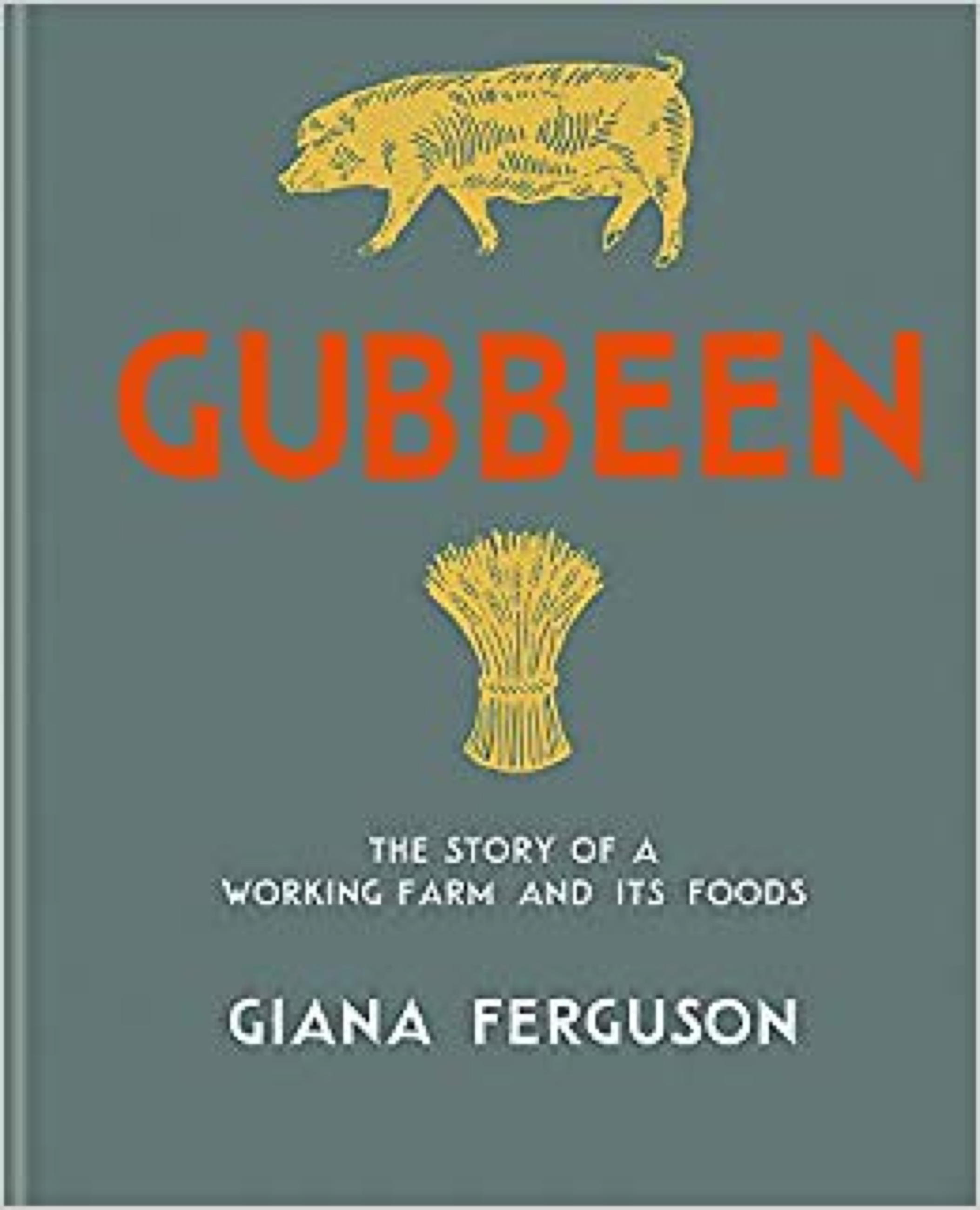
Gubbeen Gubbeen is a 250-acre, traditional farm on the most south-westerly tip of Ireland and is renowned for its award-winning cheese (called Gubbeen) and its smoked meats. The Ferguson family produces more than 50 types of food from the farm and nothing is wasted so that the circle of life sustains the family whilst creating the highest quality products for speciality shops around the world. Gubbeen: The story of a working farm and its foods is an exceptional insight into the running of this traditional farm, and encompasses the four voices of the family who runs it Giana, Tom, Fingal and Clovisse and what they do. Tom has worked the land all his life, following the old farming ways of his forbearers; Giana controls the dairy as well as keeping a keen eye on the poultry; their son Fingal uses the pigs to make bacon and smoked goods from the Smokehouse (and has a side-line in creating beautiful knives for famous chefs); and their daughter Clovisse grows chemical-free vegetables, fruit, herbs and flowers in the Kitchen Garden. Recipes are included in every section to illustrate and celebrate the farm produce, resulting in a truly inspirational read. Try Spring Lamb, Butter Beans and Dulse from the Gubbeen kitchen, or prepare the sumptuous Roast Crown of Goose, inspired by the farmyard. Gubbeen is undoubtedly most renowned for its dairy and you can have a go at creating your own Home-made Farm Cheese, or using it in recipes such as Mattie s Cauliflower and Gubbeen Ravioli or try the gorgeously gooey Gubbeen Meltdown, Gubbeen cheese baked with garlic, rosemary and thyme and served with toasted sourdough. POLITICAL SCIENCE,Public Policy,Agriculture & Food Policy (see also SOCIAL SCIENCE,Agriculture & Food)
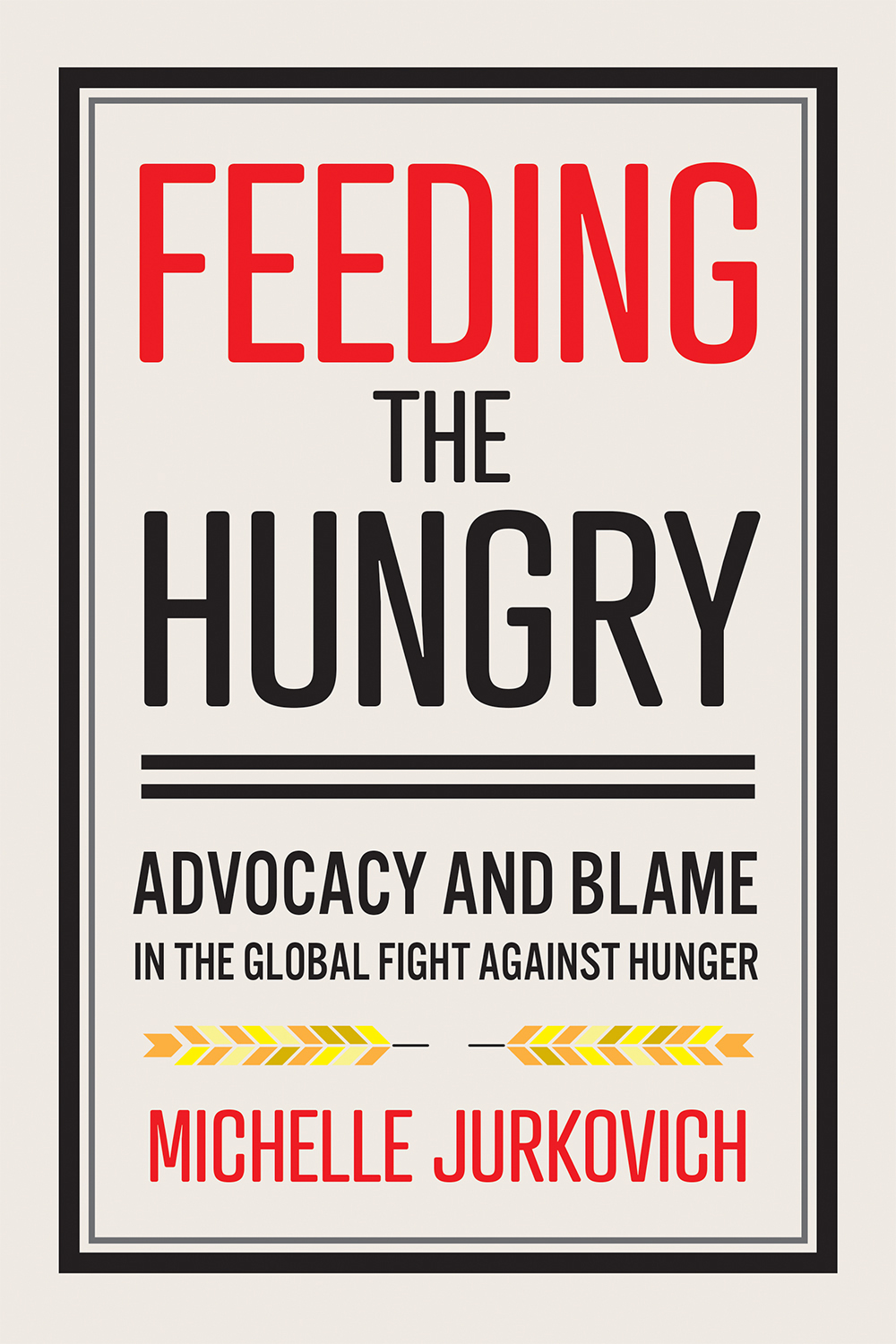
Feeding the Hungry Food insecurity poses one of the most pressing development and human security challenges in the world. In Feeding the Hungry, Michelle Jurkovich examines the social and normative environments in which international anti-hunger organizations are working and argues that despite international law ascribing responsibility to national governments to ensure the right to food of their citizens, there is no shared social consensus on who ought to do what to solve the hunger problem. Drawing on interviews with staff at top international anti-hunger organizations as well as archival research at the United Nations Food and Agriculture Organization, the UK National Archives, and the U.S. National Archives, Jurkovich provides a new analytic model of transnational advocacy. In investigating advocacy around a critical economic and social right—the right to food—Jurkovich challenges existing understandings of the relationships among human rights, norms, and laws. Most important, Feeding the Hungry provides an expanded conceptual tool kit with which we can examine and understand the social and moral forces at play in rights advocacy. POLITICAL SCIENCE,Public Policy,Agriculture & Food Policy (see also SOCIAL SCIENCE,Agriculture & Food)
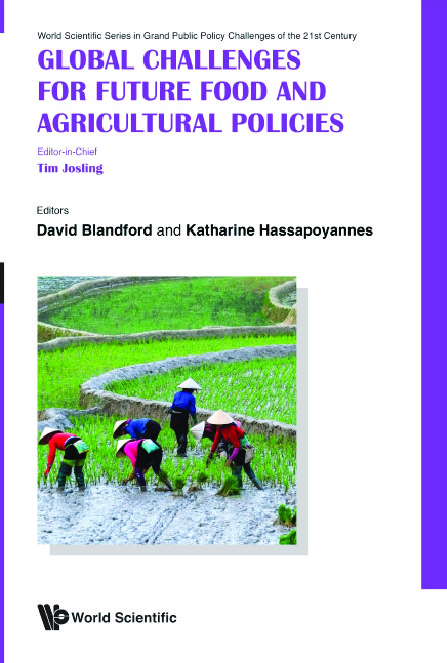
Global Challenges For Future Food And Agricultural Policies This book examines the current and future challenges facing the food and agricultural system and their implications for policymaking at the national and international level.The growth in global population and income is expected to result in increasing demand for food and agricultural raw materials, intensifying concerns over food security and increasing pressure on the planet's natural resources. Moreover, climate change — a challenge on its own — is likely to increase the urgency for reforms in the food and agricultural sector. As a substantial contributor to greenhouse gas emissions, the sector will need to participate in efforts to slow global warming and to adjust to the effects of climate change, while ensuring global food security and resource sustainability. These pressures define a new set of priorities for policymaking at the national and international level. They also necessitate changes in the framework of global institutions for effective governance of the food system.Global Challenges for Future Food and Agricultural Policies presents a comprehensive analysis of the inter-related policy challenges of food security, management of natural resources, climate change, and international governance. The book also offers valuable insights into options for effective policymaking with the goal of inducing positive policy changes to the food and agricultural sector. POLITICAL SCIENCE,Public Policy,Agriculture & Food Policy (see also SOCIAL SCIENCE,Agriculture & Food)

Japan's Dietary Transition and Its Impacts An examination of the transformation of the Japanese diet from subsistence to abundance and an assessment of the consequences for health, longevity, and the environment. In a little more than a century, the Japanese diet has undergone a dramatic transformation. In 1900, a plant-based, near-subsistence diet was prevalent, with virtually no consumption of animal protein. By the beginning of the twenty-first century, Japan's consumption of meat, fish, and dairy had increased markedly (although it remained below that of high-income Western countries). This dietary transition was a key aspect of the modernization that made Japan the world's second largest economic power by the end of the twentieth century, and it has helped Japan achieve an enviable demographic primacy, with the world's highest life expectancy and a population that is generally healthier (and thinner) than that of other modern affluent countries. In this book, Vaclav Smil and Kazuhiko Kobayashi examine Japan's gradual but profound dietary change and investigate its consequences for health, longevity, and the environment. Smil and Kobayashi point out that the gains in the quality of Japan's diet have exacted a price in terms of land use changes, water requirements, and marine resource depletion; and because Japan imports so much of its food, this price is paid globally as well as domestically. The book's systematic analysis of these diverse consequences offers the most detailed account of Japan's dietary transition available in English. POLITICAL SCIENCE,Public Policy,Agriculture & Food Policy (see also SOCIAL SCIENCE,Agriculture & Food)
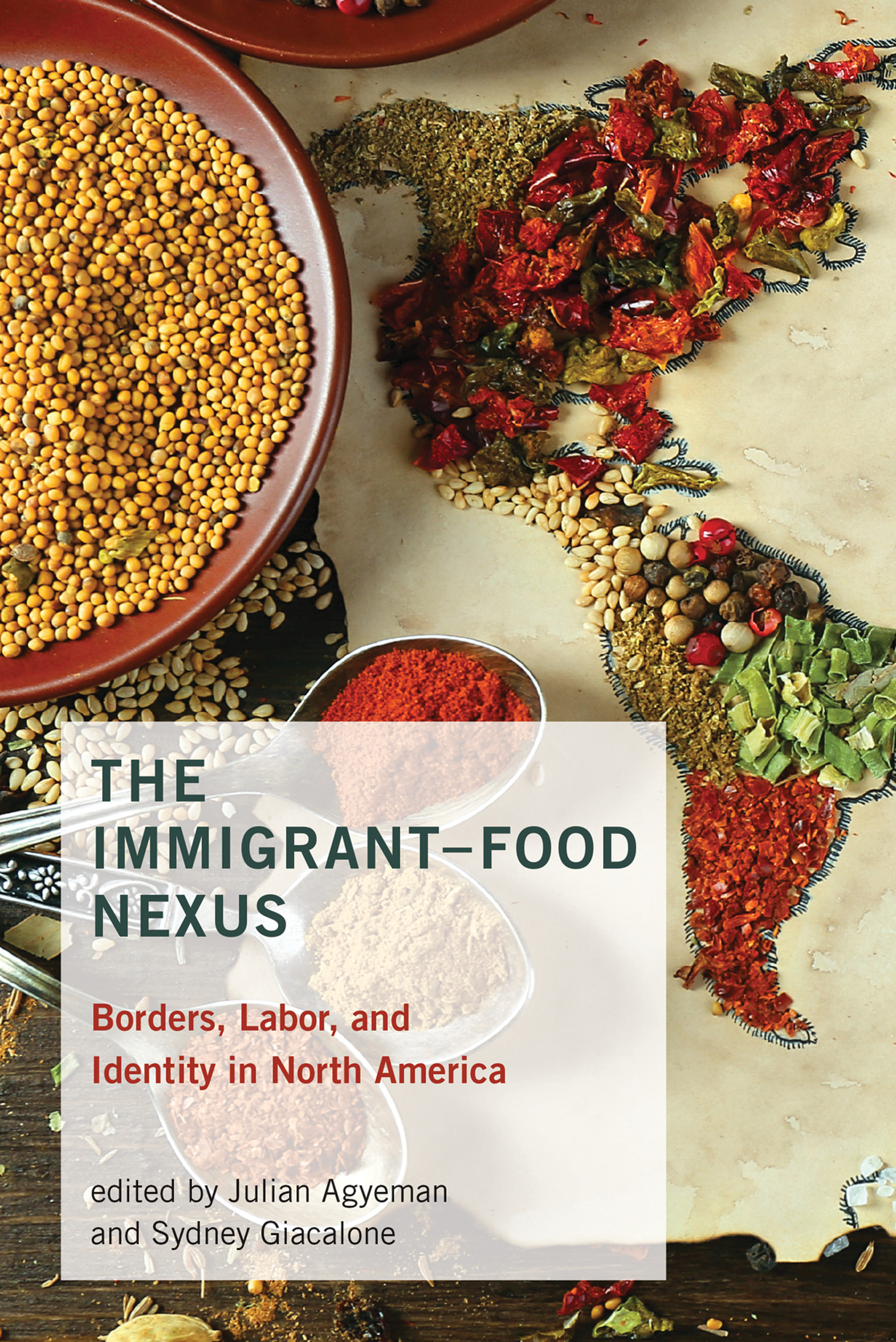
The Immigrant-Food Nexus The intersection of food and immigration in North America, from the macroscale of national policy to the microscale of immigrants' lived, daily foodways. This volume considers the intersection of food and immigration at both the macroscale of national policy and the microscale of immigrant foodways—the intimate, daily performances of identity, culture, and community through food. Taken together, the chapters—which range from an account of the militarization of the agricultural borderlands of Yuma, Arizona, to a case study of Food Policy Council in Vancouver, Canada—demonstrate not only that we cannot talk about immigration without talking about food but also that we cannot talk about food without talking about immigration. The book investigates these questions through the construct of the immigrant-food nexus, which encompasses the constantly shifting relationships of food systems, immigration policy, and immigrant foodways. The contributors, many of whom are members of the immigrant communities they study, write from a range of disciplines. Three guiding themes organize the chapters: borders—cultural, physical, and geopolitical; labor, connecting agribusiness and immigrant lived experience; and identity narratives and politics, from “local food” to “dietary acculturation.” Contributors Julian Agyeman, Alison Hope Alkon, FernandoJ. Bosco, Kimberley Curtis, Katherine Dentzman, Colin Dring, Sydney Giacalone, Sarah D. Huang, Maryam Khojasteh, Jillian Linton, Pascale Joassart-Marcelli, Samuel C. H. Mindes, Laura-Anne Minkoff-Zern, Christopher Neubert, Fabiola Ortiz Valdez, Victoria Ostenso, Catarina Passidomo, Mary Beth Schmid, Sea Sloat, Kat Vang, Hannah Wittman, Sarah Wood POLITICAL SCIENCE,Public Policy,Agriculture & Food Policy (see also SOCIAL SCIENCE,Agriculture & Food)

Craft Weed How the future of post-legalization marijuana farming can be sustainable, local, and artisanal. What will the marijuana industry look like as legalization spreads? Will corporations sweep in and create Big Marijuana, flooding the market with mass-produced weed? Or will marijuana agriculture stay true to its roots in family farming, and reflect a sustainable, local, and artisanal ethic? In Craft Weed, Ryan Stoa argues that the future of the marijuana industry should be powered by small farms—that its model should be more craft beer than Anheuser-Busch. To make his case for craft weed, Stoa interviews veteran and novice marijuana growers, politicians, activists, and investors. He provides a history of marijuana farming and its post-hippie resurgence in the United States. He reports on the amazing adaptability of the cannabis plant and its genetic gifts, the legalization movement, regulatory efforts, the tradeoffs of indoor versus outdoor farms, and the environmental impacts of marijuana agriculture. To protect and promote small farmers and their communities, Stoa proposes a Marijuana Appellation system, modeled after the wine industry, which would provide a certified designation of origin to local crops. A sustainable, local, and artisanal farming model is not an inevitable future for the marijuana industry, but Craft Weed makes clear that marijuana legalization has the potential to revitalize rural communities and the American family farm. As the era of marijuana prohibition comes to an end, now is the time to think about what kind of marijuana industry and marijuana agriculture we want. Craft Weed will help us plan for a future that is almost here. POLITICAL SCIENCE,Public Policy,Agriculture & Food Policy (see also SOCIAL SCIENCE,Agriculture & Food)
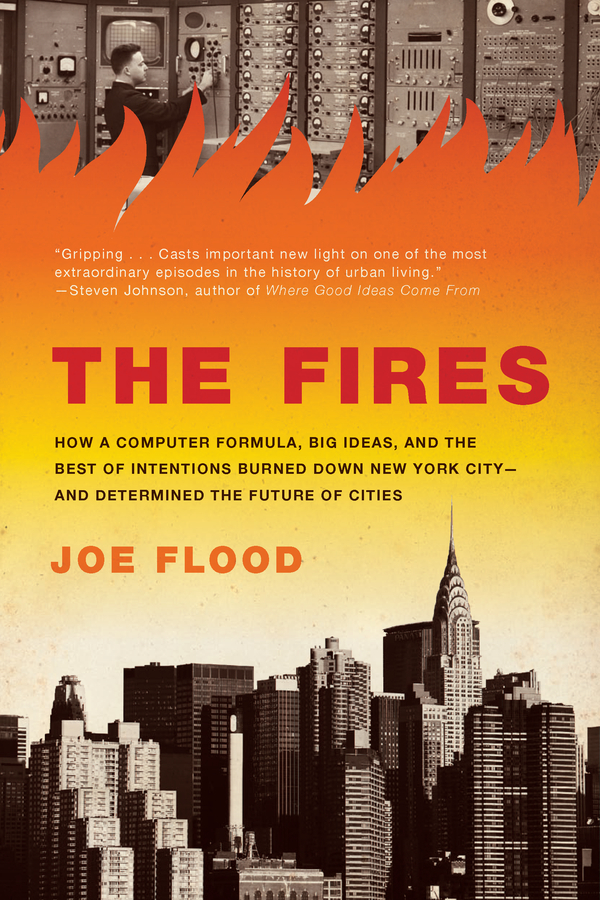
The Fires New York City, 1968. The RAND Corporation had presented an alluring proposal to a city on the brink of economic collapse: Using RAND's computer models, which had been successfully implemented in high-level military operations, the city could save millions of dollars by establishing more efficient public services. The RAND boys were the best and brightest, and bore all the sheen of modern American success. New York City, on the other hand, seemed old-fashioned, insular, and corrupt-and the new mayor was eager for outside help, especially something as innovative and infallible as "computer modeling." A deal was struck: RAND would begin its first major civilian effort with the FDNY. Over the next decade-a time New York City firefighters would refer to as "The War Years"-a series of fires swept through the South Bronx, the Lower East Side, Harlem, and Brooklyn, gutting whole neighborhoods, killing more than two thousand people and displacing hundreds of thousands. Conventional wisdom would blame arson, but these fires were the result of something altogether different: the intentional withdrawal of fire protection from the city's poorest neighborhoods-all based on RAND's computer modeling systems. Despite the disastrous consequences, New York City in the 1970s set the template for how a modern city functions-both literally, as RAND sold its computer models to cities across the country, and systematically, as a new wave of technocratic decision-making took hold, which persists to this day. In The Fires, Joe Flood provides an X-ray of these inner workings, using the dramatic story of a pair of mayors, an ambitious fire commissioner, and an even more ambitious think tank to illuminate the patterns and formulas that are now inextricably woven into the very fabric of contemporary urban life. The Fires is a must read for anyone curious about how a modern city works. POLITICAL SCIENCE,Public Policy,City Planning & Urban Development

Happy City A globe-trotting, eye-opening exploration of how cities can—and do—make us happier people Charles Montgomery's Happy City will revolutionize the way we think about urban life. After decades of unchecked sprawl, more people than ever are moving back to the city. Dense urban living has been prescribed as a panacea for the environmental and resource crises of our time. But is it better or worse for our happiness? Are subways, sidewalks, and tower dwelling an improvement on the car-dependence of sprawl? The award-winning journalist Charles Montgomery finds answers to such questions at the intersection between urban design and the emerging science of happiness, and during an exhilarating journey through some of the world's most dynamic cities. He meets the visionary mayor who introduced a "sexy" lipstick-red bus to ease status anxiety in Bogotá; the architect who brought the lessons of medieval Tuscan hill towns to modern-day New York City; the activist who turned Paris's urban freeways into beaches; and an army of American suburbanites who have transformed their lives by hacking the design of their streets and neighborhoods. Full of rich historical detail and new insights from psychologists and Montgomery's own urban experiments, Happy City is an essential tool for understanding and improving our own communities. The message is as surprising as it is hopeful: by retrofitting our cities for happiness, we can tackle the urgent challenges of our age. The happy city, the green city, and the low-carbon city are the same place, and we can all help build it. POLITICAL SCIENCE,Public Policy,City Planning & Urban Development
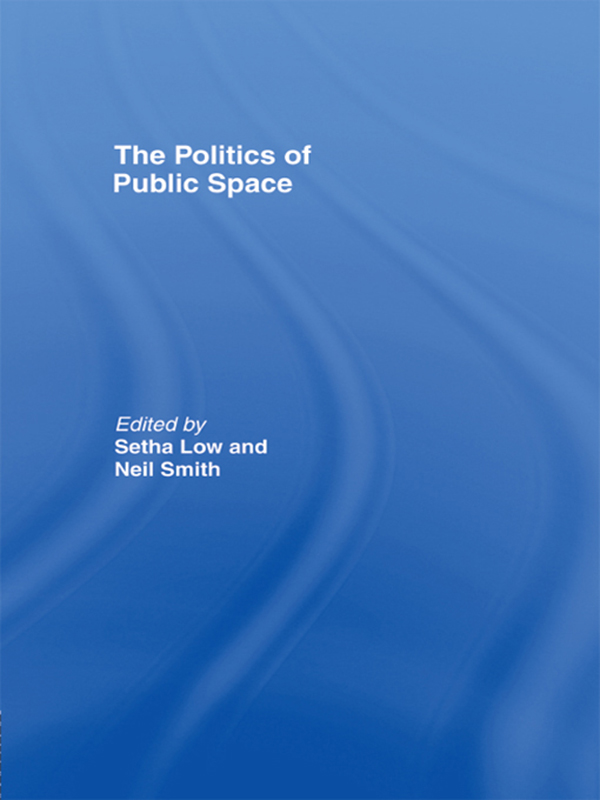
The Politics of Public Space Why is public space disappearing? Why is this disappearance important to democratic politics and how has it become an international phenomenon? Public spaces are no longer democratic spaces, but instead centres of private commerce and consumption, and even surveillance and police control. "The Politics of Public Space" extends the focus of current work on public space to include a consideration of the transnational - in the sense of moving people and transformations in the nation or state - to expand our definition of the 'public' and public space. Ultimately, public spaces are one of the last democratic forums for public dissent in a civil society. Without these significant central public spaces, individuals cannot directly participate in conflict resolution. "The Politics of Public Space" assembles a superb list of contributors to explore the important political dimensions of public space as a place where conflicts over cultural and political objectives become concrete. POLITICAL SCIENCE,Public Policy,City Planning & Urban Development
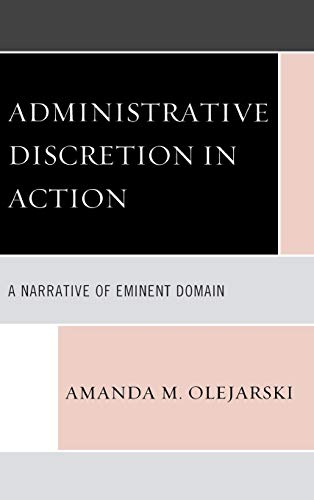
Administrative Discretion in Action Given that this book is written for scholars, practitioners, students, and community members, it emphasizes praxis, the critical interface between public administration theory and the practice of eminent domain. This book is the most comprehensive analysis on eminent domain in the field of public administration and offers unprecedented access and candor among public officials in the birthplace of Kelo and community members directly involved with the Kelo case, including Susette Kelo herself. POLITICAL SCIENCE,Public Policy,City Planning & Urban Development
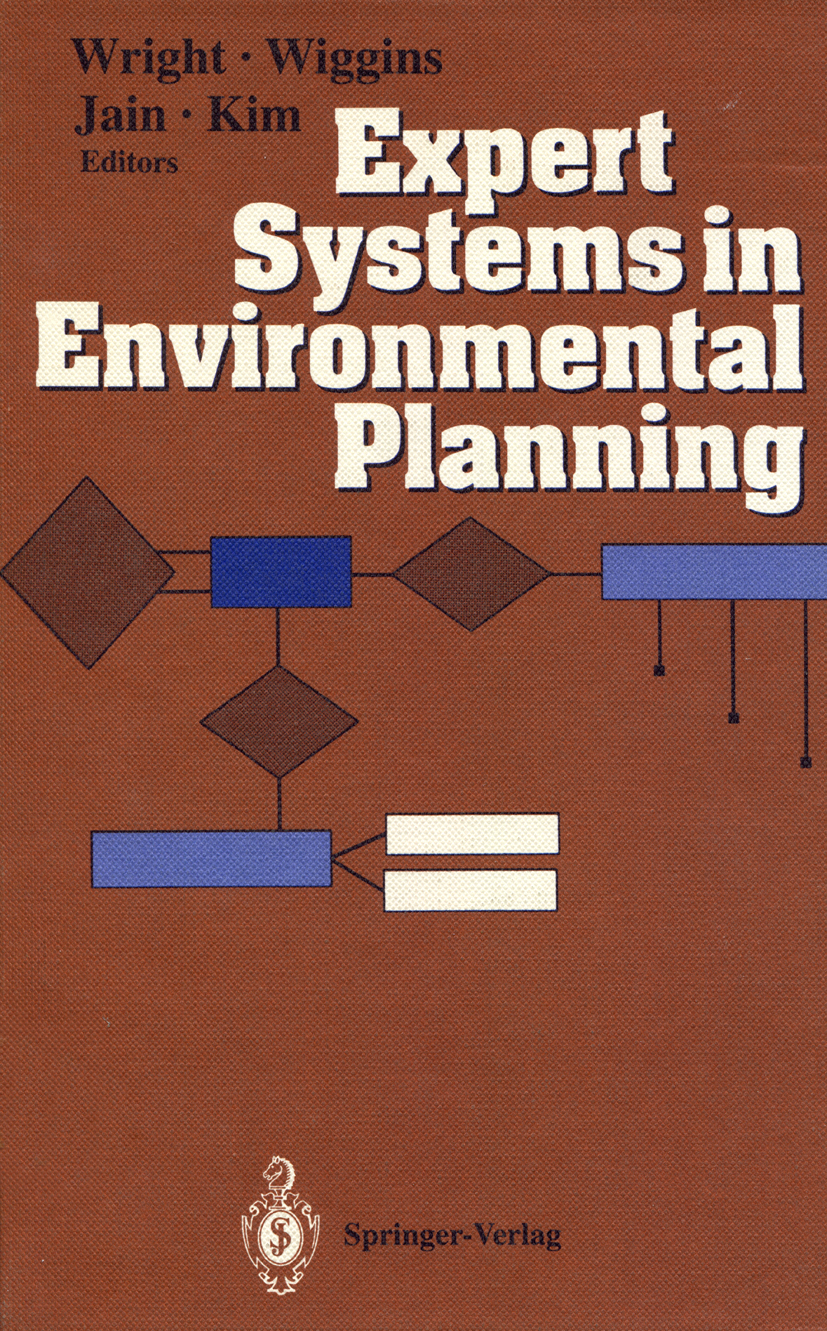
Expert Systems in Environmental Planning The connections between economics, planning, and the environment are receiv ing increased attention among scholars and policy makers in many countries. The common denominator among these three variables is the earth's life support sys tems, the ecosystems on which the world depends. When we describe our physi cal surroundings as a collection of possible uses, we are establishing linkages between economics, planning, and the environment. Because possible alternative uses compete with each other, and conflicts arise over scarce land resources, the varying environmental impacts of alternative uses are major concerns for the cur rent as well as the next generation. How to achieve sustainable development is the pressing question for today's environmental professionals. Environmental planners and engineers help us study the implications of our choices, and new technologies and techniques that improve the practice of environmental planning should enhance our ability to protect our future. The depletion of the earth's natural resources and loss of biodiversity, the deg radation of air, land, and water quality, the accumulation of greenhouse gases leading to changes in our climate, and the depletion of the ozone layer comprise only a partial list of environmental issues that concern our policy makers. To sup port their decisions, environmental planning must be a multidimensional and multidisciplinary activity that incorporates social, economic, political, geograph ical, and technical factors. Solutions for problems in these areas frequently re quire not only numerical analyses but also heuristic analyses, which in turn depend on the intuitive judgements of planners and engineers. POLITICAL SCIENCE,Public Policy,City Planning & Urban Development
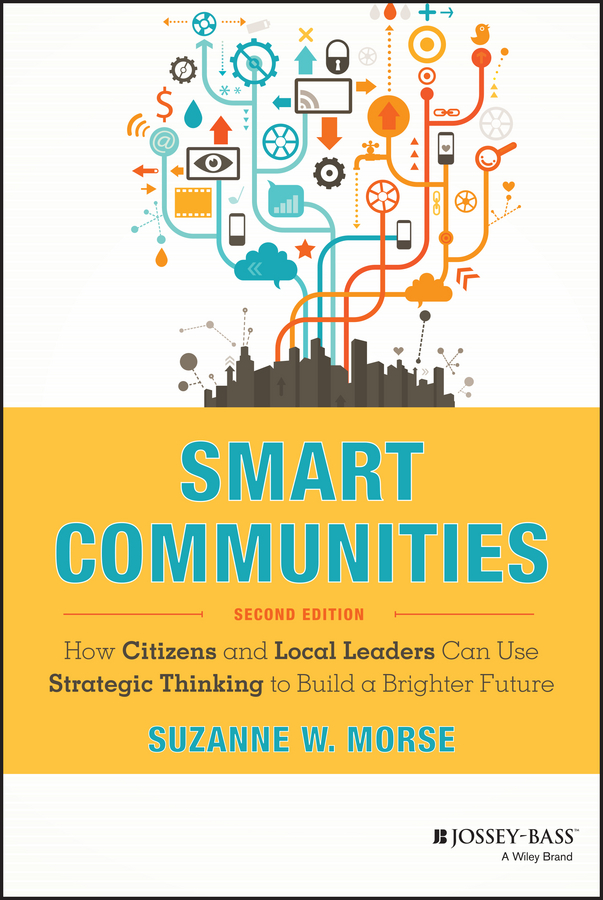
Smart Communities The new edition of the acclaimed guide to strategic decision-making in community planning, development, and collaboration Based on the results of more than a decade of research by the Pew Partnership for Civic Change, Smart Communities provides directions for strategic decision-making and outlines the key strategies used by thousands of leaders who have worked to create successful communities. Outlining seven "leverage points" for decision-making used by thousands of leaders who have worked to create successful communities, this new Second Edition offers leaders from both the public and private sectors the tools they need to build a civic infrastructure and create a better future for all the community's citizens. Second Edition has been thoroughly updated with current knowledge and research Covers new developments from current design thinking and strategy literature to innovation and invention in communities Advises on how to create community readiness that will help avert problems before they begin All case vignettes have been revised to include more detailed information about the process and application of the seven leverage points Examples from communities around the country illustrate how these change agents' well-structured decision-making processes can be traced to their effective use of the seven key leverage points Smart Communities offers hope to those who are striving to improve their communities and addresses vital issues such as poverty, race relations, and children's health and welfare. POLITICAL SCIENCE,Public Policy,City Planning & Urban Development
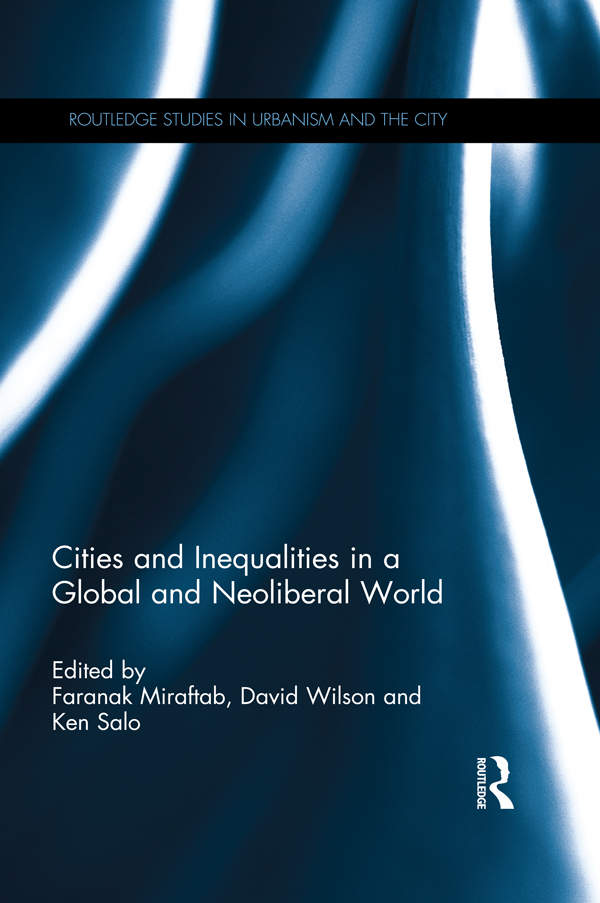
Cities and Inequalities in a Global and Neoliberal World Cities continue to be key sites for the production and contestation of inequalities generated by an ongoing but troubled neoliberal project. Neoliberalism’s onslaught across the globe now shapes diverse inequalities -- poverty, segregation, racism, social exclusion, homelessness -- as city inhabitants feel the brunt of privatization, state re-organization, and punishing social policy. This book examines the relationship between persistent neoliberalism and the production and contestation of inequalities in cities across the world. Case studies of current city realities reveal a richly place-specific and generalizable neoliberal condition that further deepens the economic, social, and political relations that give rise to diverse inequalities. Diverse cases also show how people struggle against a neoliberal ethos and hence the open-endedness of futures in these cities. POLITICAL SCIENCE,Public Policy,City Planning & Urban Development
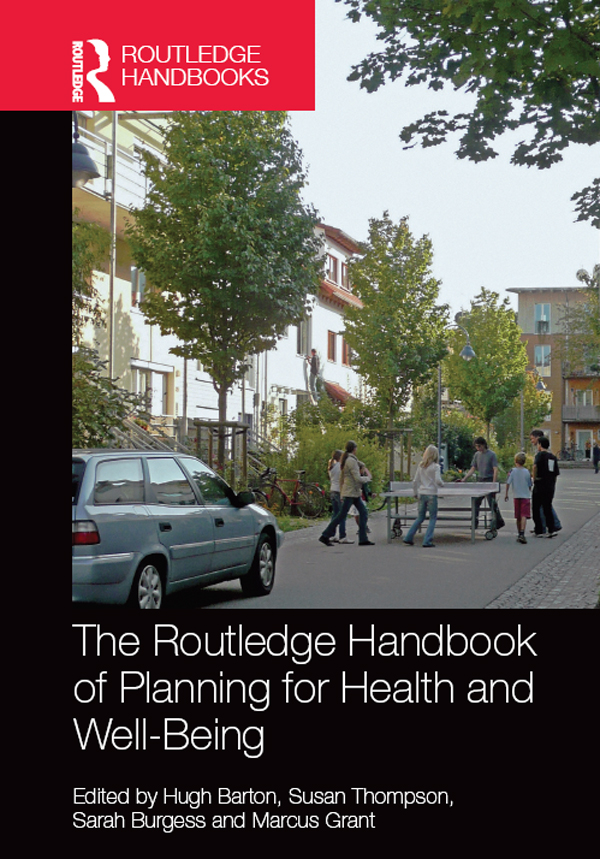
The Routledge Handbook of Planning for Health and Well-Being Urban planning is deeply implicated in both the planetary crisis of climate change and the personal crises of unhealthy lifestyles. Worldwide health issues such as obesity, mental illness, growing health inequalities and climate vulnerability cannot be solved solely by medicines but also by tackling the social, economic and environmental determinants. In a time when unhealthy and unsustainable conditions are being built into the physical fabric of cities, a new awareness and strategy is urgently needed to putting health and well-being at the heart of planning. The Routledge Handbook of Planning for Health and Well-being authoritatively and comprehensively integrates health into planning, strengthening the hands of those who argue and plan for healthy environments. With contributions from international leaders in the field, the Handbook of Planning for Health and Well-being provides context, philosophy, research, processes, and tools of experienced practitioners through case studies from four continents. POLITICAL SCIENCE,Public Policy,City Planning & Urban Development
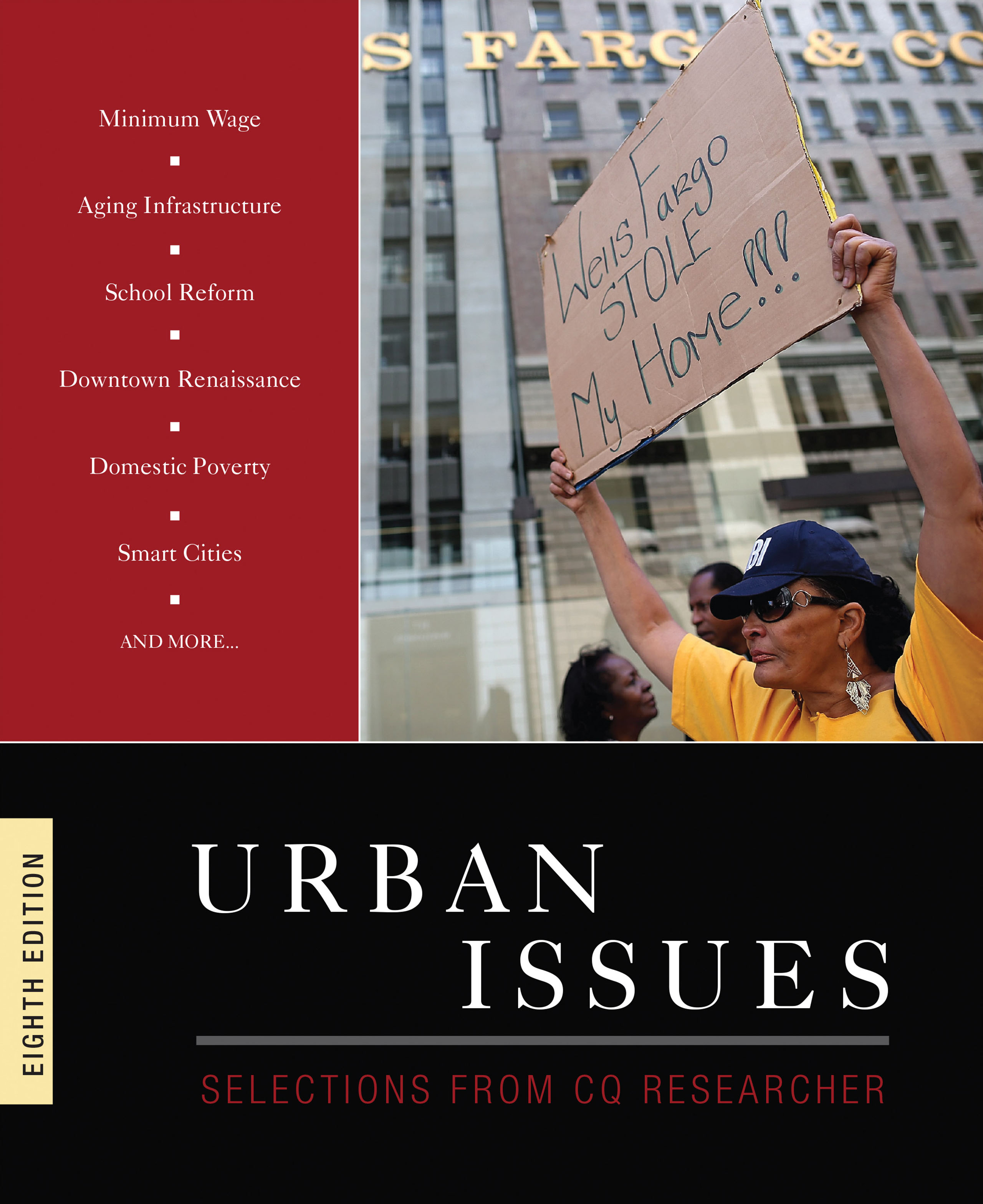
Urban Issues What are the driving forces behind Smart Cities? What are the ramifications of increasing the minimum wage? What are the causes of aging infrastructure and how should they be addressed? These are just some of the provocative questions that are considered in the new edition of Urban Issues. For current coverage of urban politics, readers will appreciate the balanced and unbiased reporting of CQ Researcher. Urban Issues provides a window into how policy is created and implemented in America’s cities and is sure to spark classroom discussions. Each chapter examines the key players, stakes, background, and lessons for the future, while covering the range of facts, analyses, and opinions surrounding each issue. POLITICAL SCIENCE,Public Policy,City Planning & Urban Development
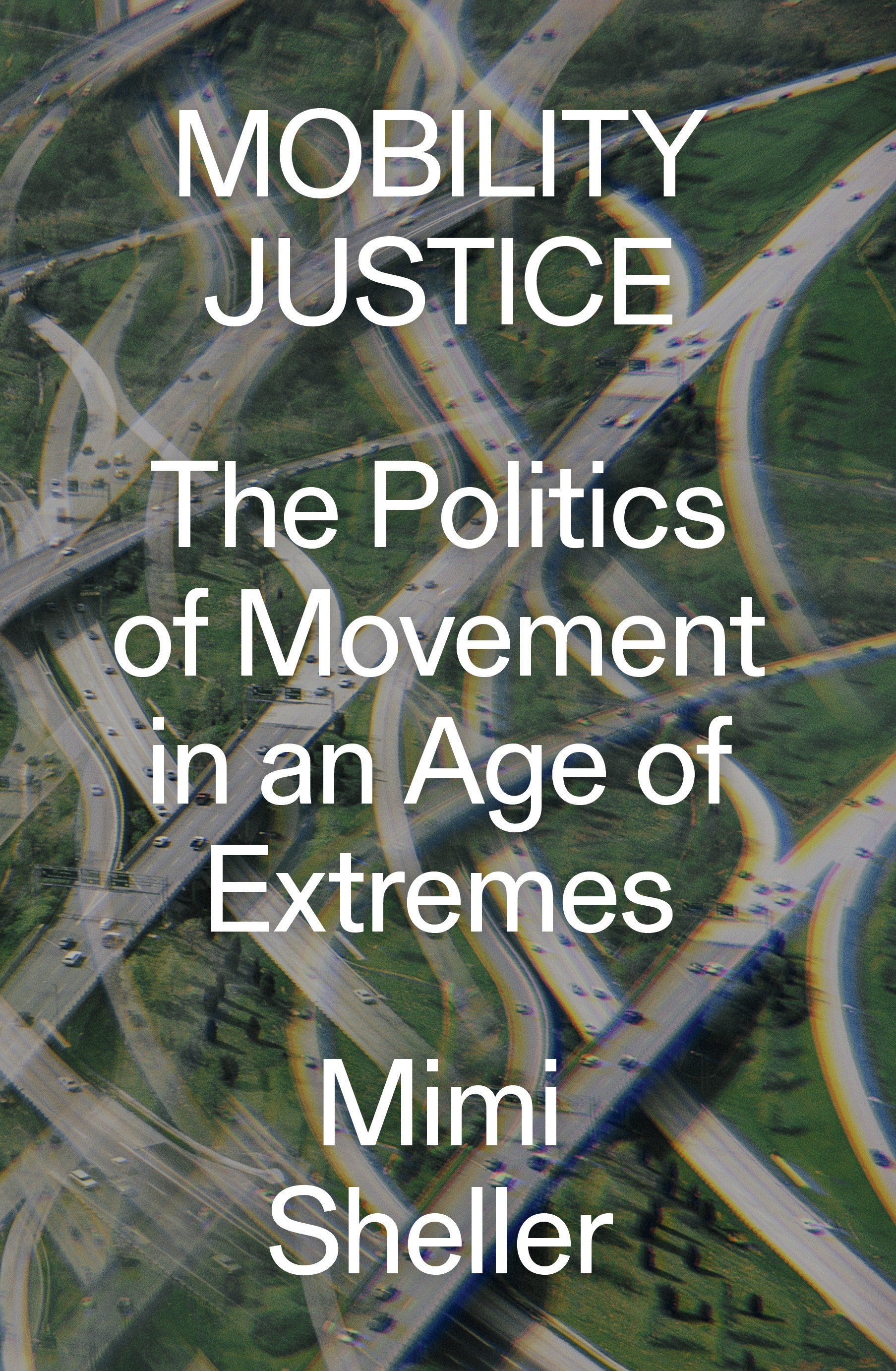
Mobility Justice Mobility justice is one of the crucial political and ethical issues of our day We are in the midst of a global climate crisis and experiencing the extreme challenges of urbanization. In Mobility Justice, Mimi Sheller makes a passionate argument for a new understanding of the contemporary crisis of movement. Sheller shows how power and inequality inform the governance and control of movement. She connects the body, street, city, nation, and planet in one overarching theory of the modern, perpetually shifting world. Concepts of mobility are examined on a local level in the circulation of people, resources, and information, as well as on an urban scale, with questions of public transport and “the right to the city.” On the planetary level, she demands that we rethink the reality where tourists and other elites are able to roam freely, while migrants and those most in need are abandoned and imprisoned at the borders. Mobility Justice is a new way to understand the deep flows of inequality and uneven accessibility in a world in which the mobility commons have been enclosed. It is a call for a new understanding of the politics of movement and a demand for justice for all. POLITICAL SCIENCE,Public Policy,City Planning & Urban Development

Urban Warfare How finance and politics have caused the global housing crisis The most comprehensive survey of the current crisis, Urban Warfare charts how the financial crisis and wider urban politics have left millions homeless and in financial desperation across the world. The financialization of housing has become a global catastrophe, leaving millions desperate and homeless. Since the 2008 financial collapse, models of home ownership, originating in the US and UK, are being exported around the world. Using examples from across the globe, Rolnik shows how our cities have been sold to construction companies and banks, while supported by government-facilitated schemes, such as “the right to buy” subsidies and micro-financing. Our homes and neighbourhoods have become the “last subprime frontiers of capitalism,” organised by those who benefit the most. POLITICAL SCIENCE,Public Policy,City Planning & Urban Development
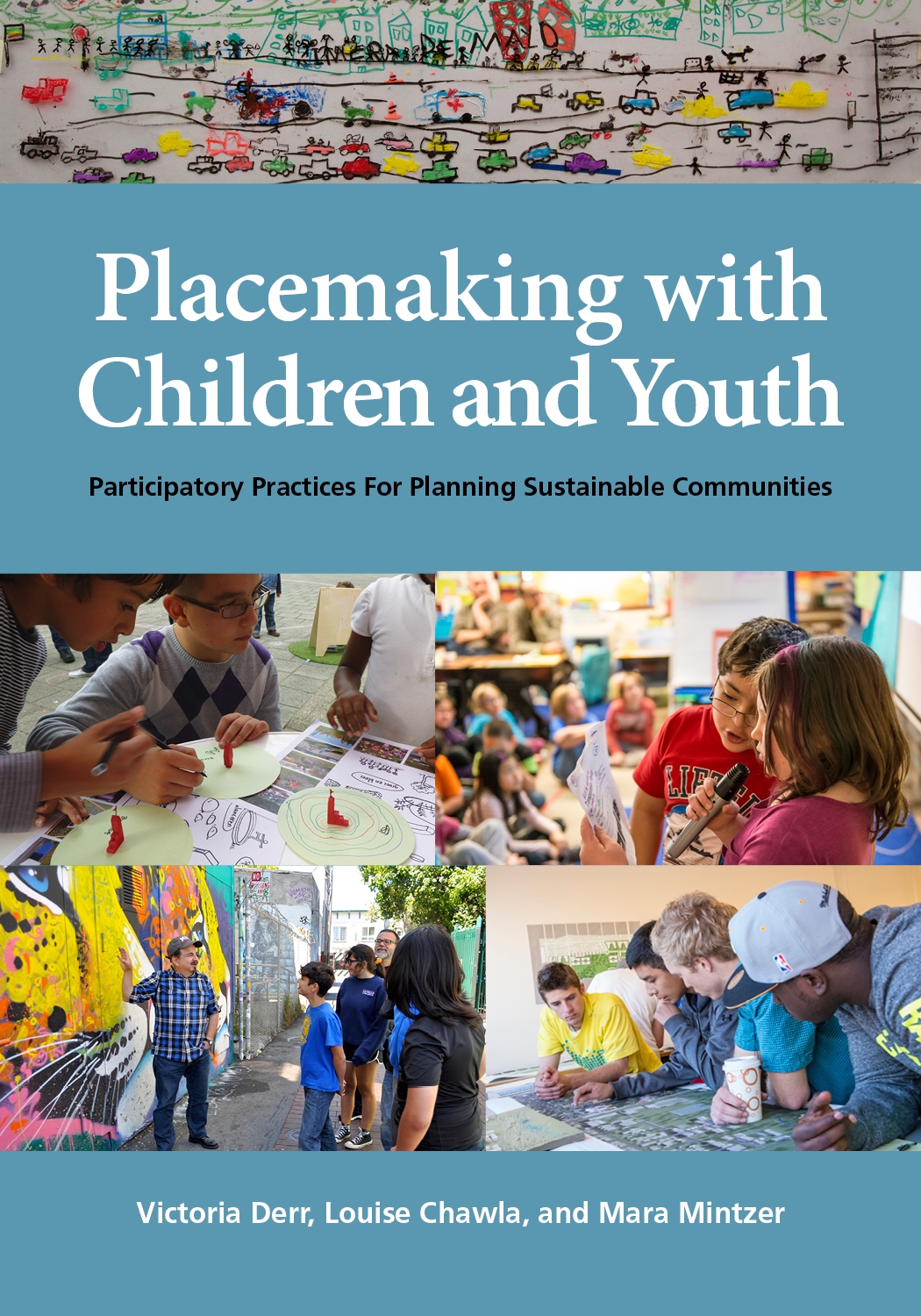
Placemaking with Children and Youth An illustrated, essential guide to engaging children and youth in the process of urban design From a history of children’s rights to case studies discussing international initiatives that aim to create child-friendly cities, Placemaking with Children and Youth offers comprehensive guidance in how to engage children and youth in the planning and design of local environments. It explains the importance of children’s active participation in their societies and presents ways to bring all generations together to plan cities with a high quality of life for people of all ages. Not only does it delineate best practices in establishing programs and partnerships, it also provides principles for working ethically with children, youth, and families, paying particular attention to the inclusion of marginalized populations. Drawing on case studies from around the world—in Australia, New Zealand, Canada, India, Puerto Rico, the Netherlands, South Africa, and the United States—Placemaking with Children and Youth showcases children’s global participation in community design and illustrates how a variety of methods can be combined in initiatives to achieve meaningful change. The book features more than 200 visuals and detailed, thoughtful guidelines for facilitating a multiplicity of participatory processes that include drawing, photography, interviews, surveys, discussion groups, role playing, mapping, murals, model making, city tours, and much more. Whether seeking information on individual methods and project planning, interpreting and analyzing results, or establishing and evaluating a sustained program, readers can find practical ideas and inspiration from six continents to connect learning to the realities of students’ lives and to create better cities for all ages. POLITICAL SCIENCE,Public Policy,City Planning & Urban Development
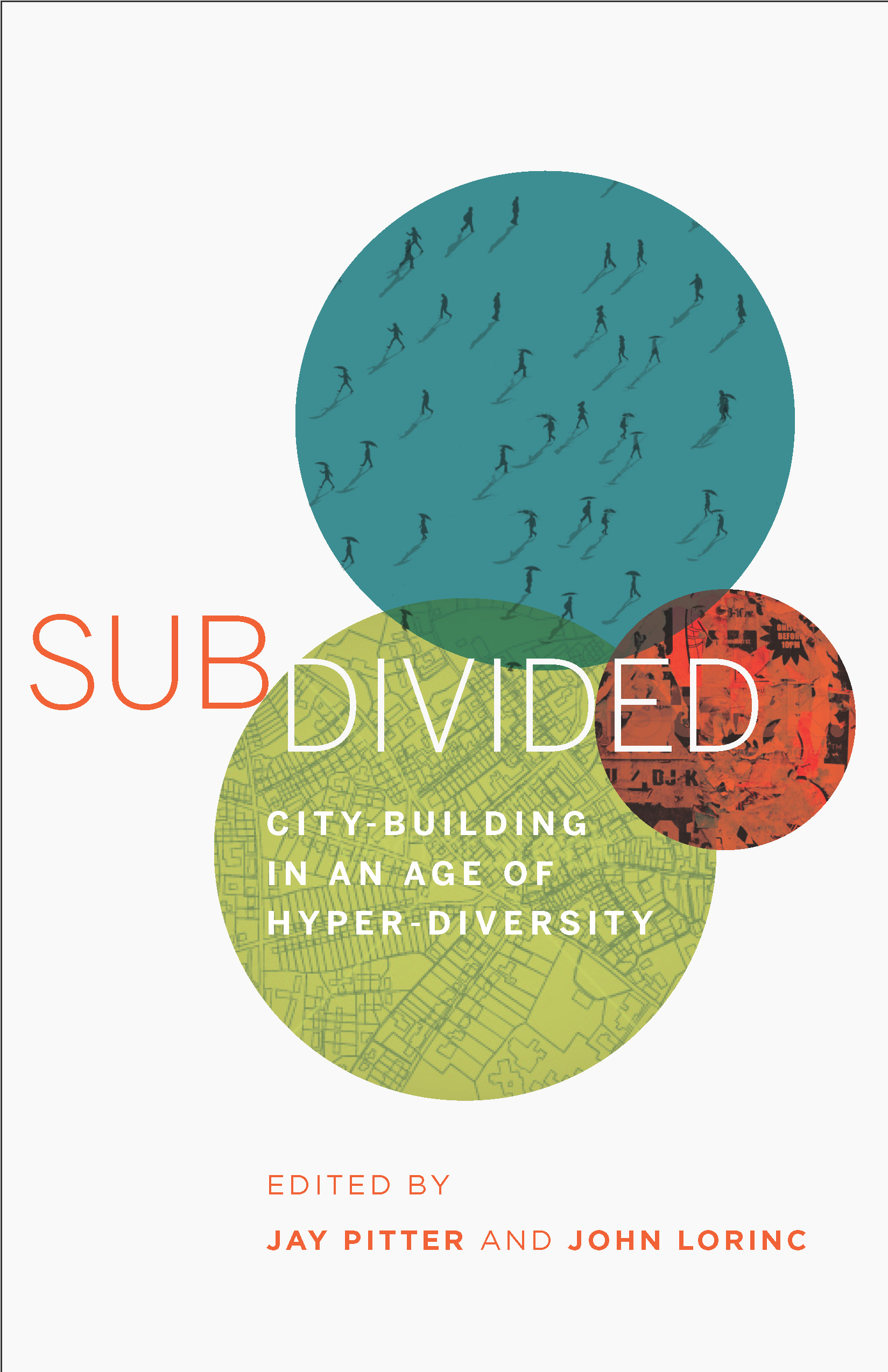
Subdivided How do we build cities where we aren't just living within the same urban space, but living together? POLITICAL SCIENCE,Public Policy,City Planning & Urban Development
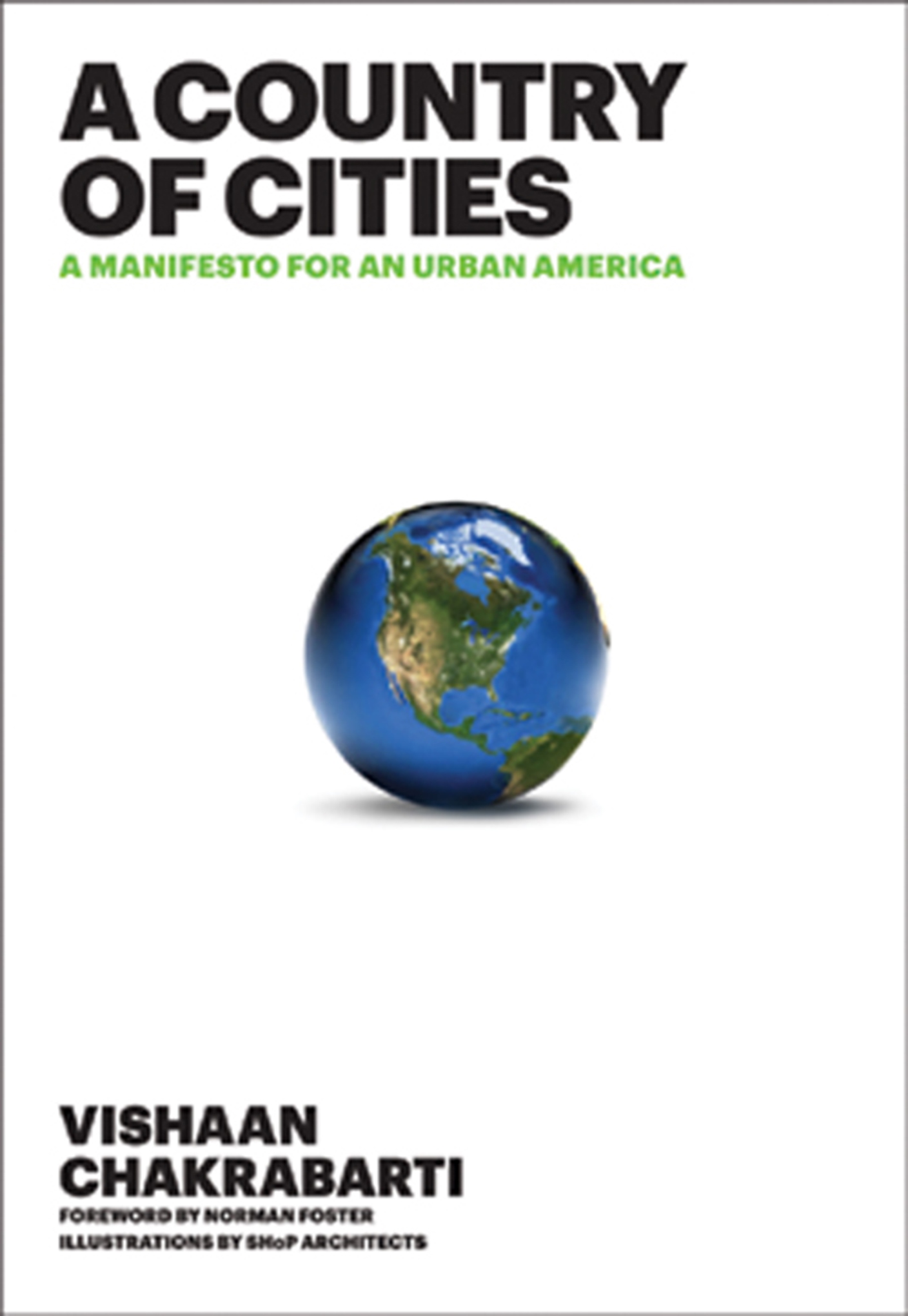
A Country of Cities In A Country of Cities, author Vishaan Chakrabarti argues that well-designed cities are the key to solving America's great national challenges: environmental degradation, unsustainable consumption, economic stagnation, rising public health costs and decreased social mobility. If we develop them wisely in the future, our cities can be the force leading us into a new era of progressive and prosperous stewardship of our nation. In compelling chapters, Chakrabarti brings us a wealth of information about cities, suburbs and exurbs, looking at how they developed across the 50 states and their roles in prosperity and globalization, sustainability and resilience, and heath and joy. Counter to what you might think, American cities today are growing faster than their suburban counterparts for the first time since the 1920s. If we can intelligently increase the density of our cities as they grow and build the transit systems, schools, parks and other infrastructure to support them, Chakrabarti shows us how both job opportunities and an improved, sustainable environment are truly within our means. In this call for an urban America, he illustrates his argument with numerous infographics illustrating provocative statistics on issues as disparate as rising childhood obesity rates, ever-lengthening automobile commutes and government subsidies that favor highways over mass transit. The book closes with an eloquent manifesto that rallies us to build a Country of Cities,†to turn a country of highways, houses and hedges into a country of trains, towers and trees. Vishaan Chakrabarti is the director of Columbia University’s Center for Urban Real Estate (CURE). In March 2012, Chakrabarti became a partner at SHoP Architects, where he will be working on such projects as the Atlantic Yards development in Brooklyn. An architect and planner, Chakrabarti has worked in both the public and private sectors: as a top executive at Related Companies; a director at the New York City Planning Commission; an associate partner at Skidmore, Owings & Merrill; a transportation planner for the Port Authority of New York and New Jersey. POLITICAL SCIENCE,Public Policy,City Planning & Urban Development
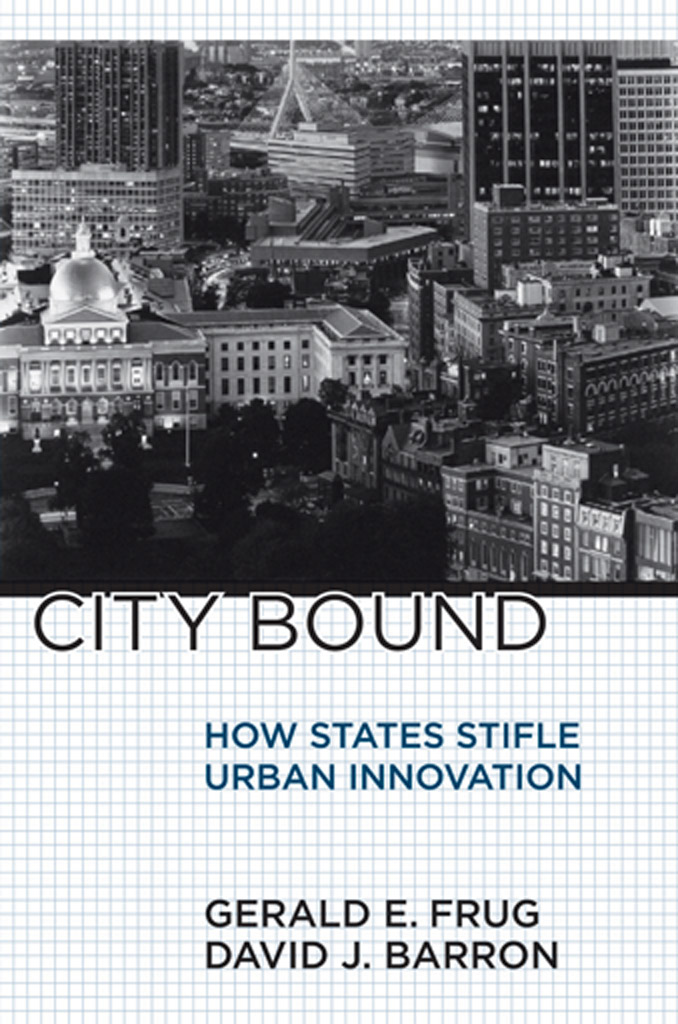
City Bound Many major American cities are defying the conventional wisdom that suburbs are the communities of the future. But as these urban centers prosper, they increasingly confront significant constraints. In City Bound, Gerald E. Frug and David J. Barron... POLITICAL SCIENCE,Public Policy,City Planning & Urban Development
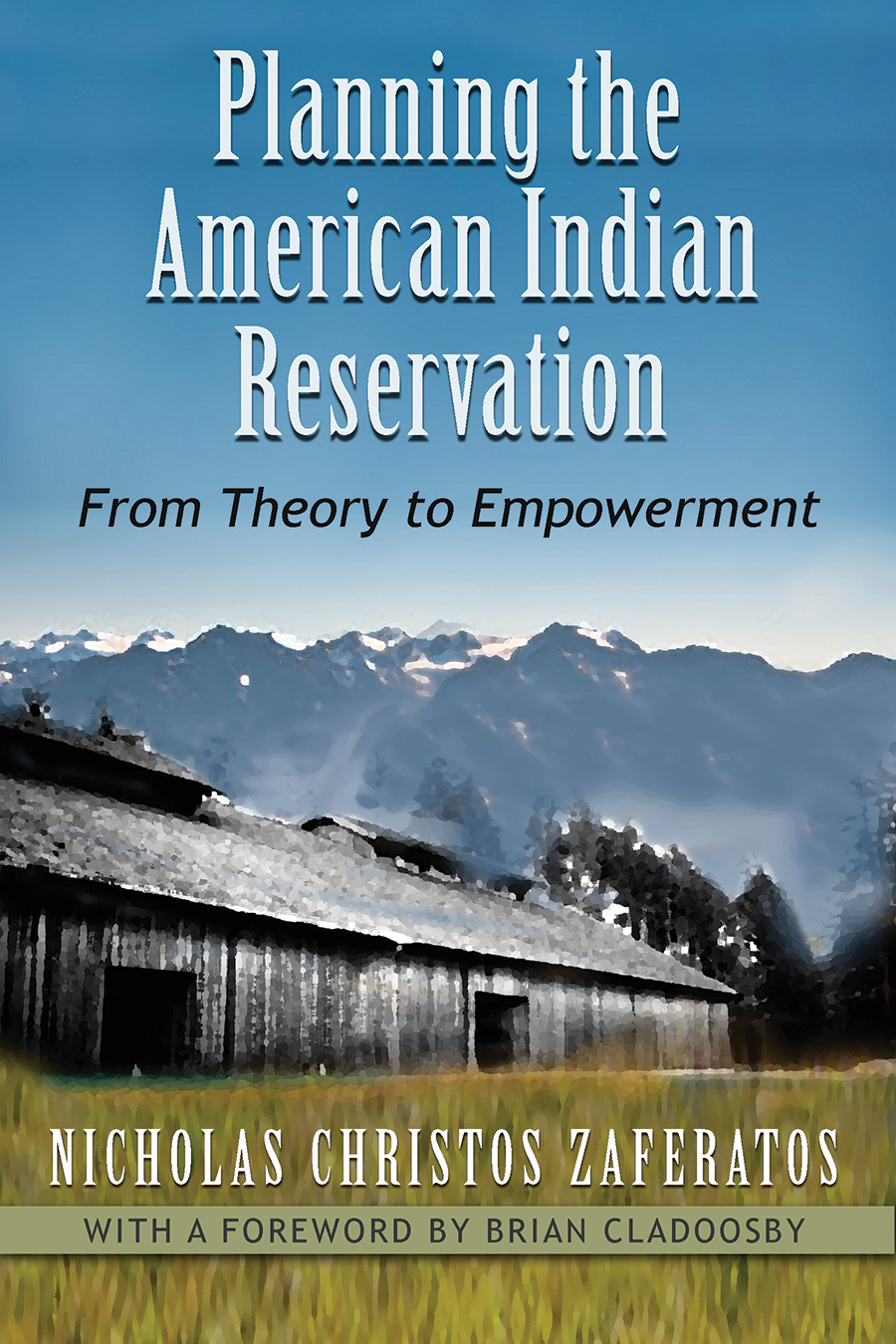
Planning the American Indian Reservation American Indian reservation planning is one of the most challenging and poorly understood specializations within the American planning profession. Charged with developing a strategy to protect irreplaceable tribal homelands that have been repeatedly diminished over the ages through unjust public policy actions, it is also one of the most imperative. For centuries tribes have faced historical bigotry, political violence, and an unrelenting resistance to self-governance.Aided by a comprehensive reservation planning strategy, tribes can create the community they envisioned for themselves, independent of outside forces. In Planning the American Indian Reservation, Zaferatos presents a holistic and practical approach to explaining the practice of Native American planning.The book unveils the complex conditions that tribes face by examining the historic, political, legal, and theoretical dimensions of the tribal planning situation in order to elucidate the context within which reservation planning occurs. Drawing on more than thirty years of professional practice, Zaferatos presents several case studies demonstrating how effective tribal planning can alter thenature of the political landscape and help to rebalance the uneven relationships that have been formed between tribal governments and their nontribal political counterparts. Tribal planning’s overarching objective is to assist tribes as they transition from passive objects of historical circumstances to principal actors in shaping their future reservation communities. POLITICAL SCIENCE,Public Policy,City Planning & Urban Development
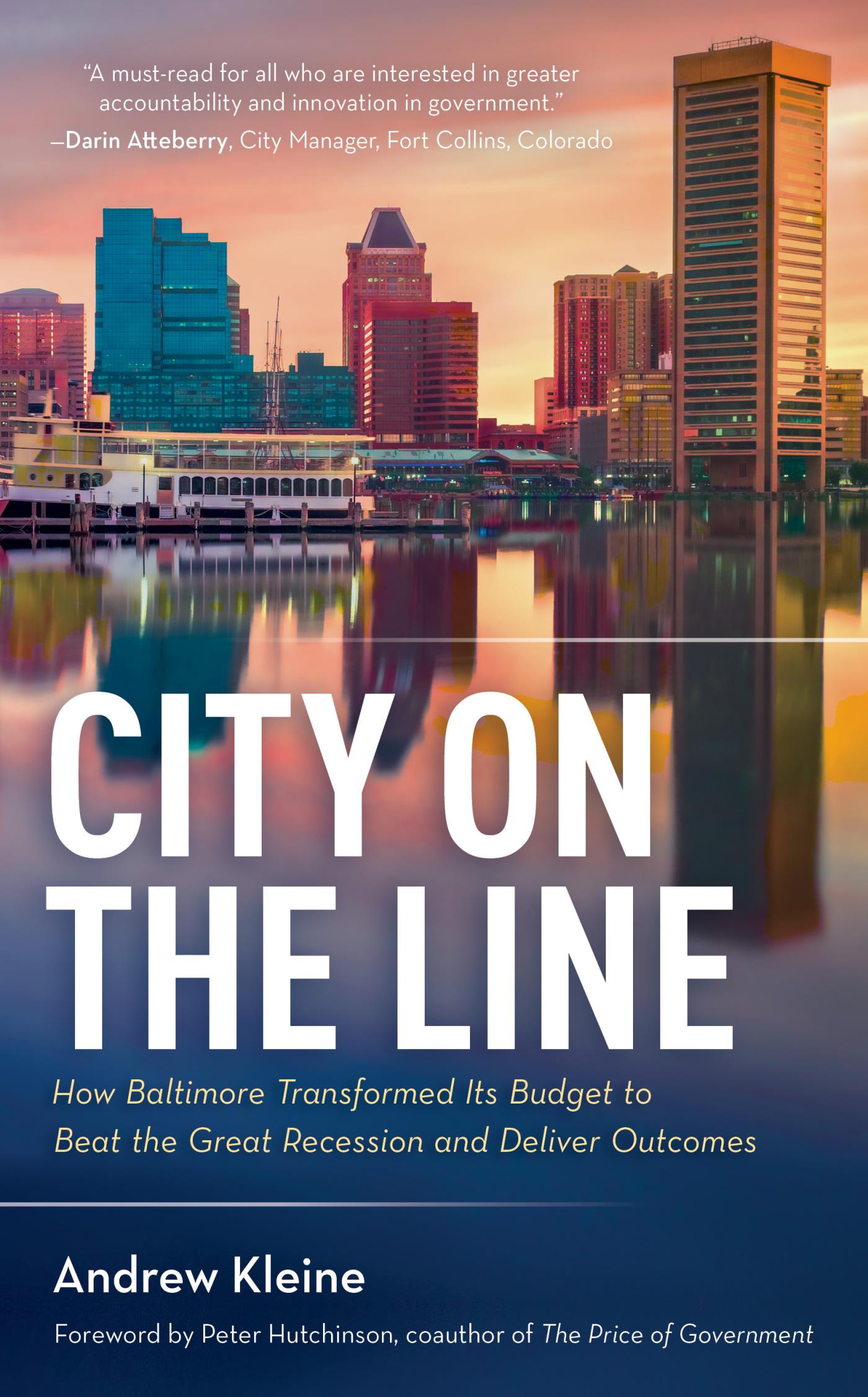
City on the Line City on the Line is about a revolution in public budgeting. It is the story of a hard luck city fighting through the Great Recession, a budget director trying to lead disruptive change, and a groundbreaking effort to link strategy, budget and data to get better results for residents. POLITICAL SCIENCE,Public Policy,City Planning & Urban Development

The Right to the Smart City Globally, Smart Cities initiatives are pursued which reproduce the interests of capital and neoliberal government, rather than wider public good. This book explores smart urbanism and 'the right to the city', examining citizenship, social justice, commoning, civic participation, and co-creation to imagine a different kind of Smart City. POLITICAL SCIENCE,Public Policy,City Planning & Urban Development

Opportunity Knocks In this memoir about overcoming adversity in America, the U. S. Senator responsible for creating "opportunity zones" explains how hard work and community growth can drive businesses and end poverty. Senator Tim Scott knows adversity. As the son of a single mother from North Charleston, South Carolina, he struggled to get through school and had his dreams of a college football career shattered by a car wreck. But thanks to his mother and a few mentors along the way, he learned that "failure isn't failure unless you quit." He also learned that it's hard work and perseverance, not a government handout, that will get you ahead in life. Today, Senator Scott is the only black Republican in the Senate, and he believes that investment and commerce are the best ways to rebuild our most impoverished communities. This is the idea behind his signature piece of legislation, the "opportunity zones" program, which President Trump has strongly endorsed. The program provides tax incentives for businesses that invest in low-income urban areas, seeking to replace things like welfare and government assistance. In Opportunity Knocks, Senator Scott will tell his life story with a focus on adversity and opportunity. He will teach readers about the principles of hard work and hope while addressing the dangers of veering too far toward socialist policies. The book will also not shy away from discussions of racism and racial inequality in the United States and will recount some of Senator Scott's own brushes with racism as well as the many discussions he's had with people who want to help, including President Trump. POLITICAL SCIENCE,Public Policy,City Planning & Urban Development
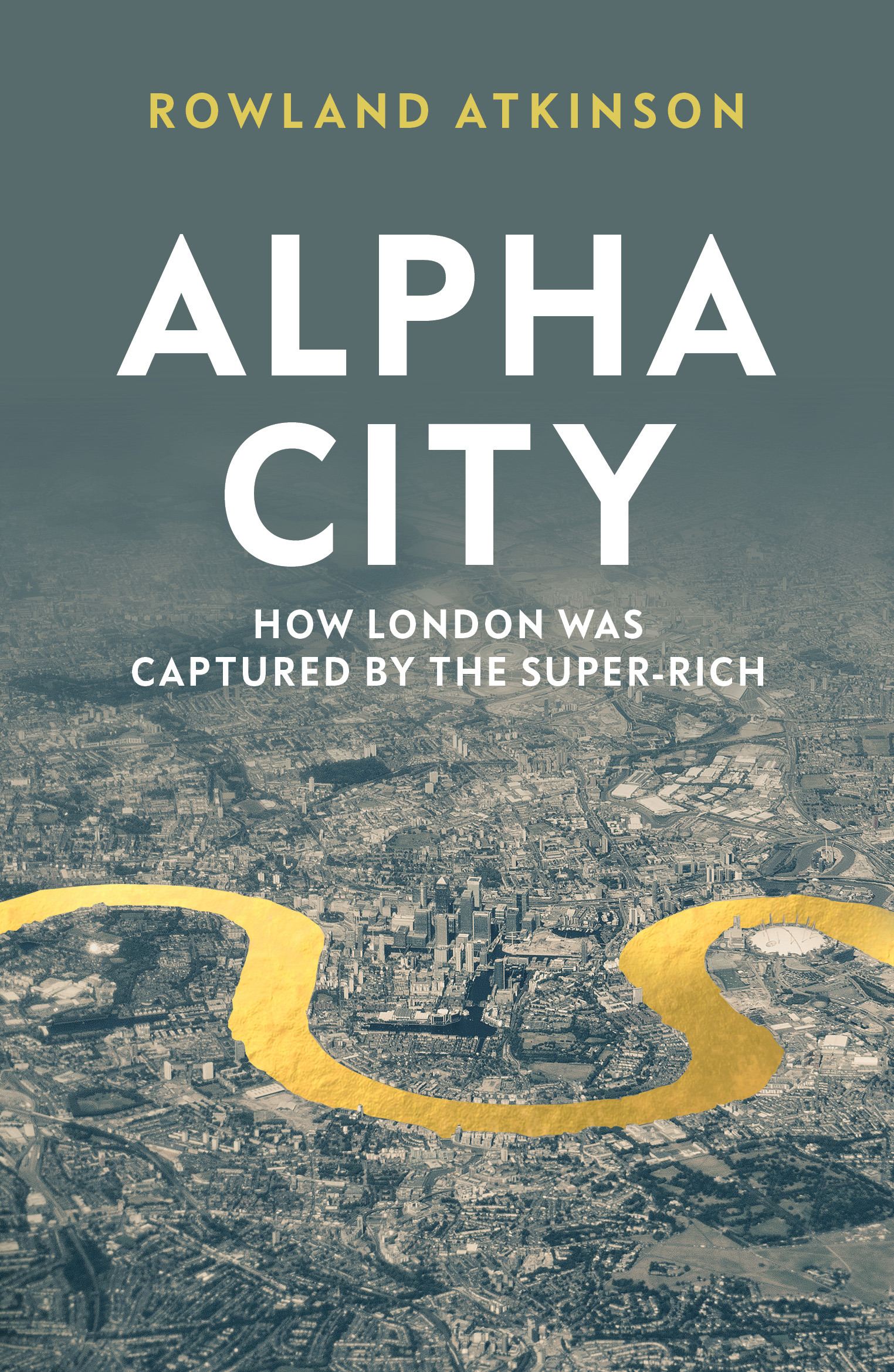
Alpha City How London was bought and sold by the Super-Rich, and what it means for the rest of us Who owns London? In recent decades, it has fallen into the hands of the super-rich. It is today the essential “World City” for High-Net-Worth Individuals and Ultra-High-Net-Worth Individuals. Compared to New York or Tokyo, the two cities that bear the closest comparison, it has the largest number of wealthy people per head of population. Taken as a whole, London is the epicentre of the world’s finance markets, an elite cultural hub, and a place to hide one’s wealth. Rowland Atkinson presents a history of the property boom economy, going back to the end of Empire. It tells the story of eager developers, sovereign wealth and grasping politicians, all paving the way for the wealthy colonisation of the cityscape. The consequences of this transformation of the capital for capital is the brutal expulsion of the urban poor, austerity, cuts, demolitions, and a catalogue of social injustices. This Faustian pact has resulted in the sale and destruction of public assets, while the rich turn a blind eye toward criminal money laundering to feather their own nests. Alpha City moves from gated communities and the mega-houses of the super-rich to the disturbing rise of evictions and displacements from the city. It shows how the consequences of widening inequality have an impact on the urban landscape. POLITICAL SCIENCE,Public Policy,City Planning & Urban Development
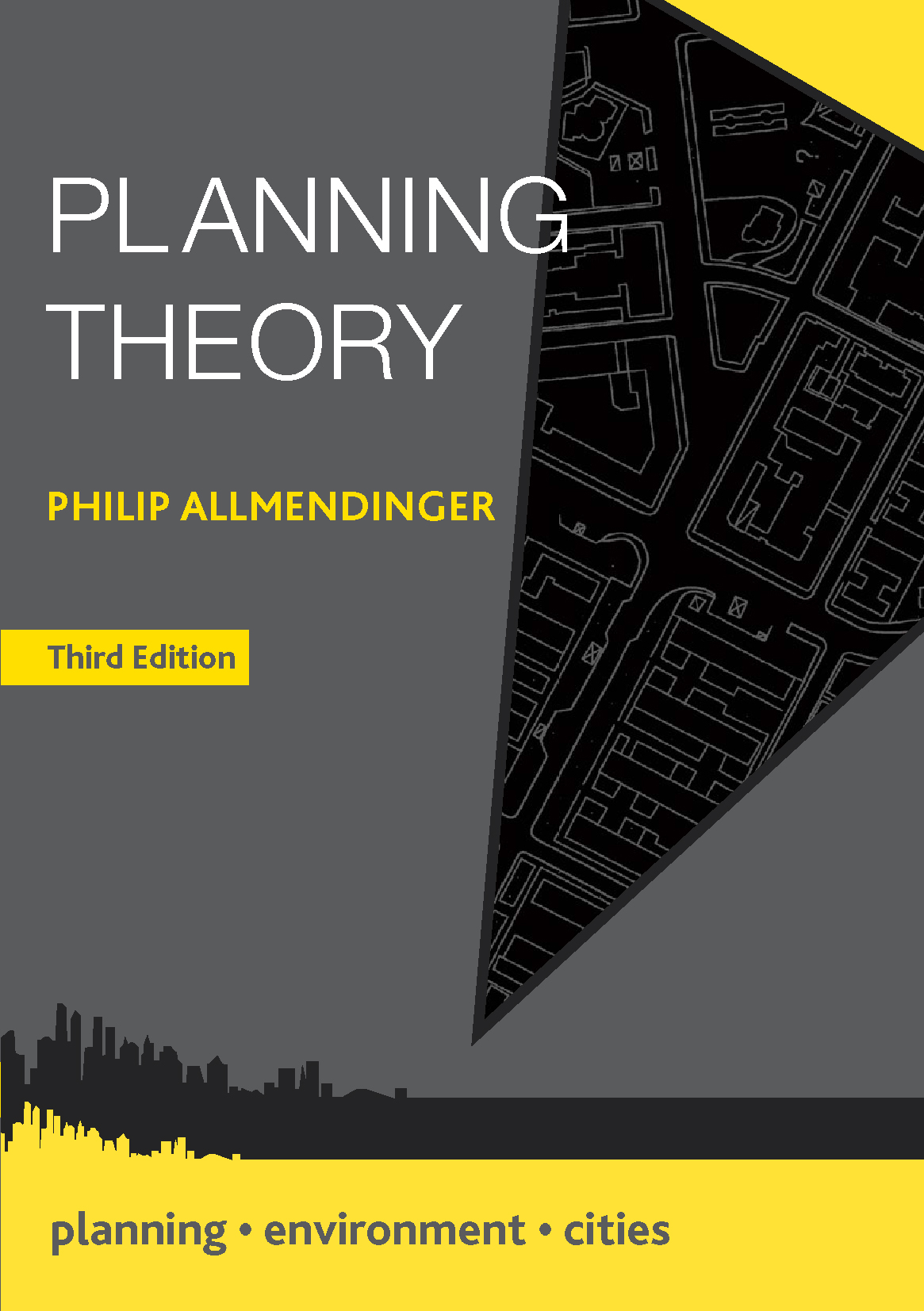
Planning Theory In the 3rd edition of the leading introductory textbook to planning theory, Allmendinger provides a wide-ranging and up-to-date analysis of planning theories, how these relate to planning practice, and their significance. Moving away from a linear, chronological model of progress over time from one paradigm to another, Allmendinger explains how and why different theories have gained dominance in particular places at particular times, giving the reader a holistic view of the field of scholarship and to demonstrate the relevance of planning theory for practise. Planning theory has undergone significant changes in recent decades as new theories and perspectives have emerged. Allmendigner takes care to detail the historical evolution of planning theory and the key philosophical issues involved so as enable the reader to both understand and critique theories as they encounter them. This much revised edition of Philip Allmendinger's text draws upon both established theories and expands its scope of current thinking around neoliberalism, post-colonialism and post-structuralist thinking on politics, space and scale. This unique approach to planning theory means this is an essential for all students completing planning theory courses in Urban or Planning studies, at both undergraduate and postgraduate level. POLITICAL SCIENCE,Public Policy,City Planning & Urban Development
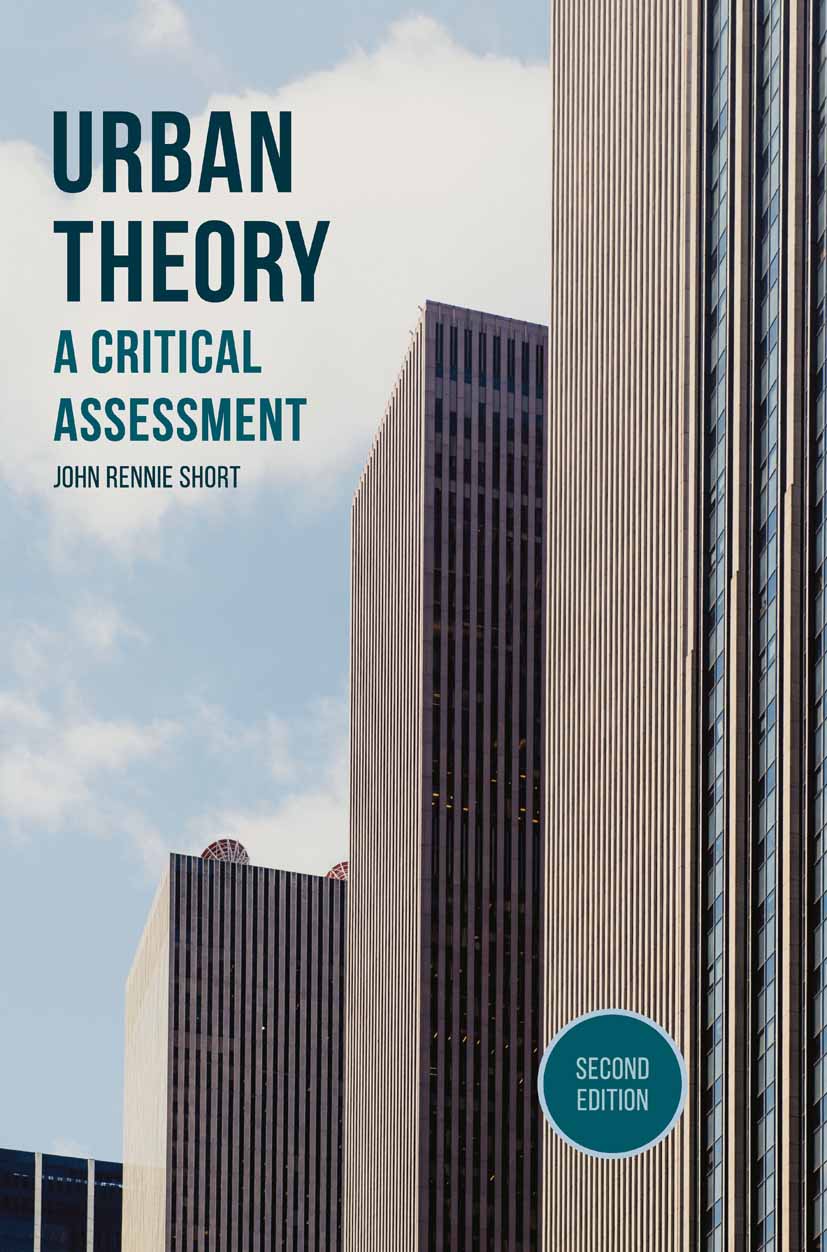
Urban Theory This wide-ranging and state-of-the-art new edition reviews the classic contributions to understanding modern and post-modern cities, and is comprehensively updated to take account of the issues and concepts at stake in 21st century urban theory. POLITICAL SCIENCE,Public Policy,City Planning & Urban Development

What Do We Know and What Should We Do About Housing? By taking aim at the ‘property machine’ and its opposition to the social and everyday needs of the majority of the population, the authors analyse some of the key social and economic forces and the broad range of policies that have shaped and responded to Britain’s housing crisis. Before concluding with a series of innovative proposals that would allow for the establishment of a fairer and more equal society and a more stable economic future. POLITICAL SCIENCE,Public Policy,City Planning & Urban Development
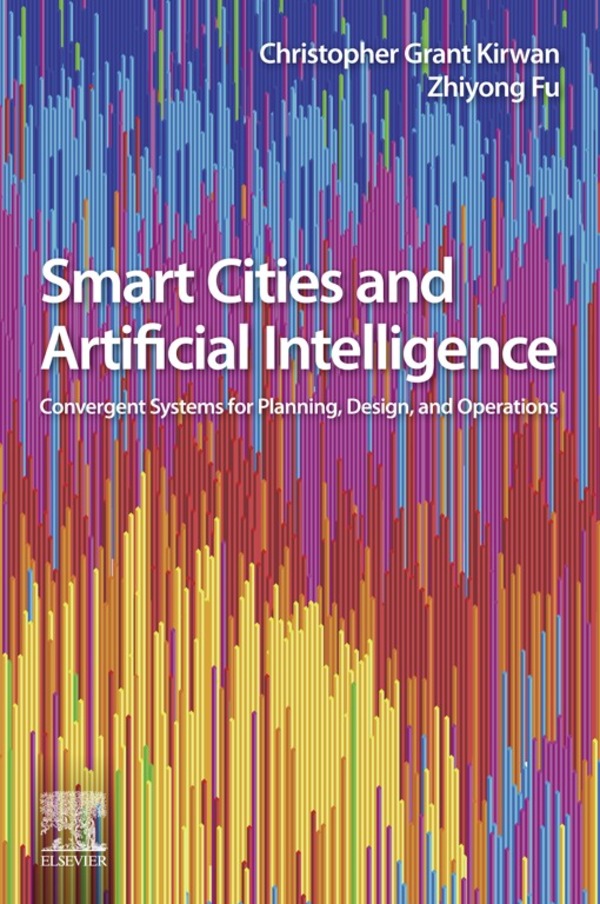
Smart Cities and Artificial Intelligence Smart Cities and Artificial Intelligence offers a comprehensive view of how cities are evolving as smart ecosystems through the convergence of technologies incorporating machine learning and neural network capabilities, geospatial intelligence, data analytics and visualization, sensors, and smart connected objects. These recent advances in AI move us closer to developing urban operating systems that simulate human, machine, and environmental patterns from transportation infrastructure to communication networks. Exploring cities as real-time, living, dynamic systems, and providing tools and formats including generative design and living lab models that support cities to become self-regulating, this book provides readers with a conceptual and practical knowledge base to grasp and apply the key principles required in the planning, design, and operations of smart cities. Smart Cities and Artificial Intelligence brings a multidisciplinary, integrated approach, examining how the digital and physical worlds are converging, and how a new combination of human and machine intelligence is transforming the experience of the urban environment. It presents a fresh holistic understanding of smart cities through an interconnected stream of theory, planning and design methodologies, system architecture, and the application of smart city functions, with the ultimate purpose of making cities more liveable, sustainable, and self-sufficient. Explores concepts in smart city design and development and the transformation of cities through the convergence of human, machine, and natural systems enabled by Artificial Intelligence (AI) Includes numerous diagrams to illustrate and explain complex smart city systems and solutions Features diverse smart city examples and initiatives from around the globe POLITICAL SCIENCE,Public Policy,City Planning & Urban Development
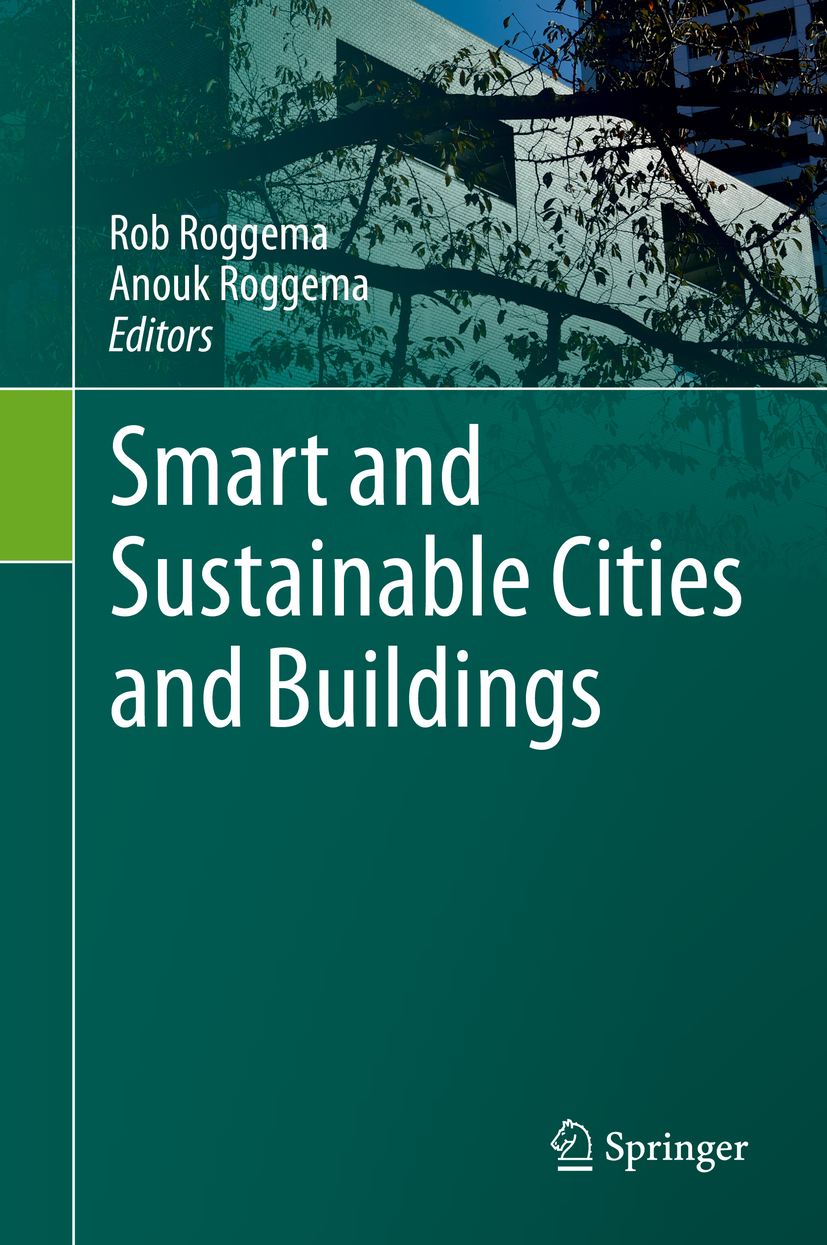
Smart and Sustainable Cities and Buildings This book brings together the papers presented at the Smart and Sustainable Built Environments Conference, 2018 (SASBE).This latest research falls into two tracks: smart and sustainable design and planning cities; and the technicalities of smart and sustainable buildings. The growth of smart cities is evident, but not always linked to sustainability. This book gives an overview of the latest academic developments in increasing the smartness and sustainability of our cities and buildings. Aspects such as inclusivity, smart cities, place and space, the resilient city, urbanity and urban ecology are prominently featured in the design and planning part of the book; while energy, educational buildings, comfort, building design, construction and performance form the sub-themes of the technical part of the book. This book will appeal to urban designers, architects, urban planners, smart city designers and sustainable building experts. POLITICAL SCIENCE,Public Policy,City Planning & Urban Development

Mind and Places This book explores the contributions of psychological, neuroscientific and philosophical perspectives to the design of contemporary cities. Pursuing an innovative and multidisciplinary approach, it addresses the need to re-launch knowledge and creativity as major cultural and institutional bases of human communities. Dwelling is a form of knowledge and re-invention of reality that involves both the tangible dimension of physical places and their mental representation. Findings in the neuroscientific field are increasingly opening stimulating perspectives on the design of spaces, and highlight how our ability to understand other people is strongly related to our corporeity. The first part of the book focuses on the contributions of various disciplines that deal with the spatial dimension, and explores the dovetailing roles that science and art can play from a multidisciplinary perspective. In turn, the second part formulates proposals on how to promote greater integration between the aesthetic and cultural dimension in spatial design. Given its scope, the book will benefit all scholars, academics and practitioners who are involved in the process of planning, designing and building places, and will foster an international exchange of research, case studies, and theoretical reflections to confront the challenges of designing conscious places and enable the development of communities. POLITICAL SCIENCE,Public Policy,City Planning & Urban Development
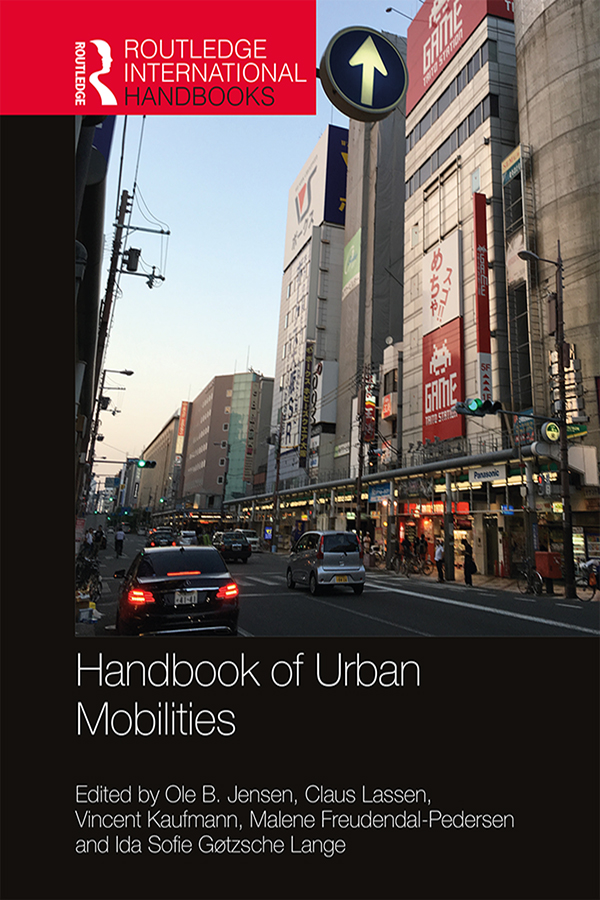
Handbook of Urban Mobilities This book offers the reader a comprehensive understanding and the multitude of methods utilized in the research of urban mobilities with cities and ‘the urban’ as its pivotal axis. It covers theories and concepts for scholars and researchers to understand, observe and analyse the world of urban mobilities. The Handbook of Urban Mobilities facilitates the understanding of urban mobilities within a historic conscience of societal transformation. It explores key concepts and theories within the ‘mobilities turn’ with a particular urban framework, as well as the methods and tools at play when empirical, urban mobilities research is undertaken. This book also explores the urban mobilities practices related to commutes; particular modes of moving; the exploration of everyday life and embodied practices as they manifest themselves within urban mobilities; and the themes of power, conflict, and social exclusion. A discussion of urban planning, public control, and governance is also undertaken in the book, wherein the themes of infrastructures, technologies and design are duly considered. With chapters written in an accessible style, this handbook carries timely contributions within the contemporary state of the art of urban mobilities research. It will thus be useful for academics and students of graduate programmes and post-graduate studies within disciplines such as urban geography, political science, sociology, anthropology, urban planning, traffic and transportation planning, and architecture and urban design. POLITICAL SCIENCE,Public Policy,City Planning & Urban Development

Urban Ethics Under Conditions Of Crisis Urban Ethics under Conditions of Crisis investigates the states of urban planning, architectural design, sustainability, landscape architecture, and engineering, and examines their correlation with social attitudes and dispositions that can impact on socio-cultural and political engagement internationally in conditions of crisis. The theme of the book emphasizes the need to acknowledge the controversial character of contemporary social life under critical social conditions, in correlation with urban space. It concerns the evaluation of critical issues such as: POLITICAL SCIENCE,Public Policy,City Planning & Urban Development

Smart Cities For Dummies Become empowered to build and maintain smarter cities At its core, a smart city is a collection of technological responses to the growing demands, challenges, and complexities of improving the quality of life for billions of people now living in urban centers across the world. The movement to create smarter cities is still in its infancy, but ambitious and creative projects in all types of cities—big and small—around the globe are beginning to make a big difference. New ideas, powered by technology, are positively changing how we move humans and products from one place to another; create and distribute energy; manage waste; combat the climate crisis; build more energy efficient buildings; and improve basic city services through digitalization and the smart use of data. Inside this book you’ll find out: What it really means to create smarter cities How our urban environments are being transformed Big ideas for improving the quality of life for communities Guidance on how to create a smart city strategy The essential role of data in building better cities The major new technologies ready to make a difference in every community Smart Cities For Dummies will give you the knowledge to understand this important topic in depth and be ready to be an agent of change in your community. POLITICAL SCIENCE,Public Policy,City Planning & Urban Development

The Affordable City From Los Angeles to Boston and Chicago to Miami, US cities are struggling to address the twin crises of high housing costs and household instability. Debates over the appropriate course of action have been defined by two poles: building more housing or enacting stronger tenant protections. These options are often treated as mutually exclusive, with support for one implying opposition to the other. Shane Phillips believes that effectively tackling the housing crisis requires that cities support both tenant protections and housing abundance. He offers readers more than 50 policy recommendations, beginning with a set of principles and general recommendations that should apply to all housing policy. The remaining recommendations are organized by what he calls the Three S's of Supply, Stability, and Subsidy. Phillips makes a moral and economic case for why each is essential and recommendations for making them work together. There is no single solution to the housing crisis—it will require a comprehensive approach backed by strong, diverse coalitions. The Affordable City is an essential tool for professionals and advocates working to improve affordability and increase community resilience through local action. POLITICAL SCIENCE,Public Policy,City Planning & Urban Development

Order without Design An argument that operational urban planning can be improved by the application of the tools of urban economics to the design of regulations and infrastructure. Urban planning is a craft learned through practice. Planners make rapid decisions that have an immediate impact on the ground—the width of streets, the minimum size of land parcels, the heights of buildings. The language they use to describe their objectives is qualitative—“sustainable,” “livable,” “resilient”—often with no link to measurable outcomes. Urban economics, on the other hand, is a quantitative science, based on theories, models, and empirical evidence largely developed in academic settings. In this book, the eminent urban planner Alain Bertaud argues that applying the theories of urban economics to the practice of urban planning would greatly improve both the productivity of cities and the welfare of urban citizens. Bertaud explains that markets provide the indispensable mechanism for cities' development. He cites the experience of cities without markets for land or labor in pre-reform China and Russia; this “urban planners' dream” created inefficiencies and waste. Drawing on five decades of urban planning experience in forty cities around the world, Bertaud links cities' productivity to the size of their labor markets; argues that the design of infrastructure and markets can complement each other; examines the spatial distribution of land prices and densities; stresses the importance of mobility and affordability; and critiques the land use regulations in a number of cities that aim at redesigning existing cities instead of just trying to alleviate clear negative externalities. Bertaud concludes by describing the new role that joint teams of urban planners and economists could play to improve the way cities are managed. POLITICAL SCIENCE,Public Policy,City Planning & Urban Development
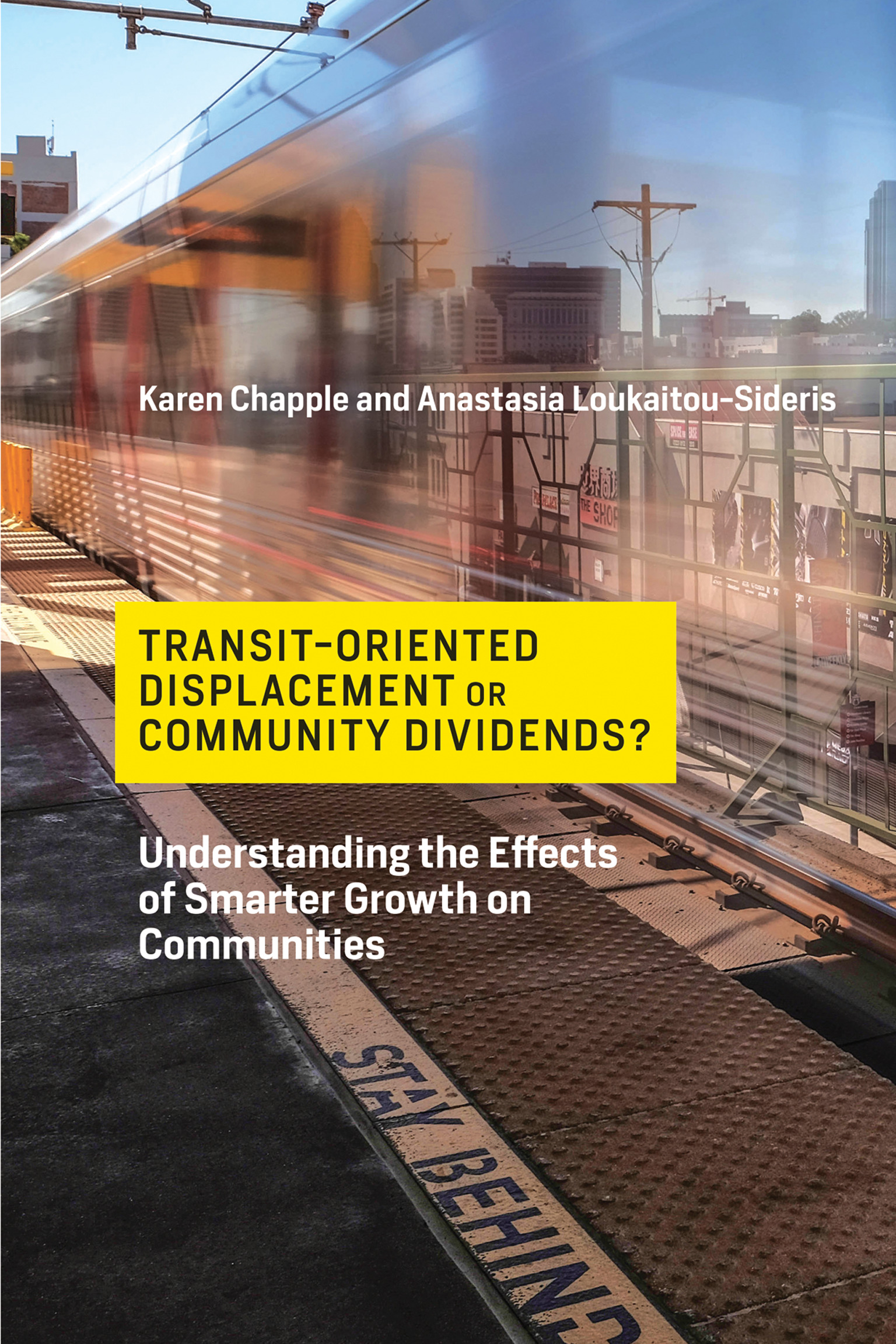
Transit-Oriented Displacement or Community Dividends? An examination of the neighborhood transformation, gentrification, and displacement that accompany more compact development around transit. Cities and regions throughout the world are encouraging smarter growth patterns and expanding their transit systems to accommodate this growth, reduce greenhouse gas emissions, and satisfy new demands for mobility and accessibility. Yet despite a burgeoning literature and various policy interventions in recent decades, we still understand little about what happens to neighborhoods and residents with the development of transit systems and the trend toward more compact cities. Research has failed to determine why some neighborhoods change both physically and socially while others do not, and how race and class shape change in the twenty-first-century context of growing inequality. Drawing on novel methodological approaches, this book sheds new light on the question of who benefits and who loses from more compact development around new transit stations. Building on data at multiple levels, it connects quantitative analysis on regional patterns with qualitative research through interviews, field observations, and photographic documentation in twelve different California neighborhoods. From the local to the regional to the global, Chapple and Loukaitou-Sideris examine the phenomena of neighborhood transformation, gentrification, and displacement not only through an empirical lens but also from theoretical and historical perspectives. Growing out of an in-depth research process that involved close collaboration with dozens of community groups, the book aims to respond to the needs of both advocates and policymakers for ideas that work in the trenches. POLITICAL SCIENCE,Public Policy,City Planning & Urban Development

The Smart Enough City Why technology is not an end in itself, and how cities can be “smart enough,” using technology to promote democracy and equity. Smart cities, where technology is used to solve every problem, are hailed as futuristic urban utopias. We are promised that apps, algorithms, and artificial intelligence will relieve congestion, restore democracy, prevent crime, and improve public services. In The Smart Enough City, Ben Green warns against seeing the city only through the lens of technology; taking an exclusively technical view of urban life will lead to cities that appear smart but under the surface are rife with injustice and inequality. He proposes instead that cities strive to be “smart enough”: to embrace technology as a powerful tool when used in conjunction with other forms of social change—but not to value technology as an end in itself. In a technology-centric smart city, self-driving cars have the run of downtown and force out pedestrians, civic engagement is limited to requesting services through an app, police use algorithms to justify and perpetuate racist practices, and governments and private companies surveil public space to control behavior. Green describes smart city efforts gone wrong but also smart enough alternatives, attainable with the help of technology but not reducible to technology: a livable city, a democratic city, a just city, a responsible city, and an innovative city. By recognizing the complexity of urban life rather than merely seeing the city as something to optimize, these Smart Enough Cities successfully incorporate technology into a holistic vision of justice and equity. POLITICAL SCIENCE,Public Policy,City Planning & Urban Development
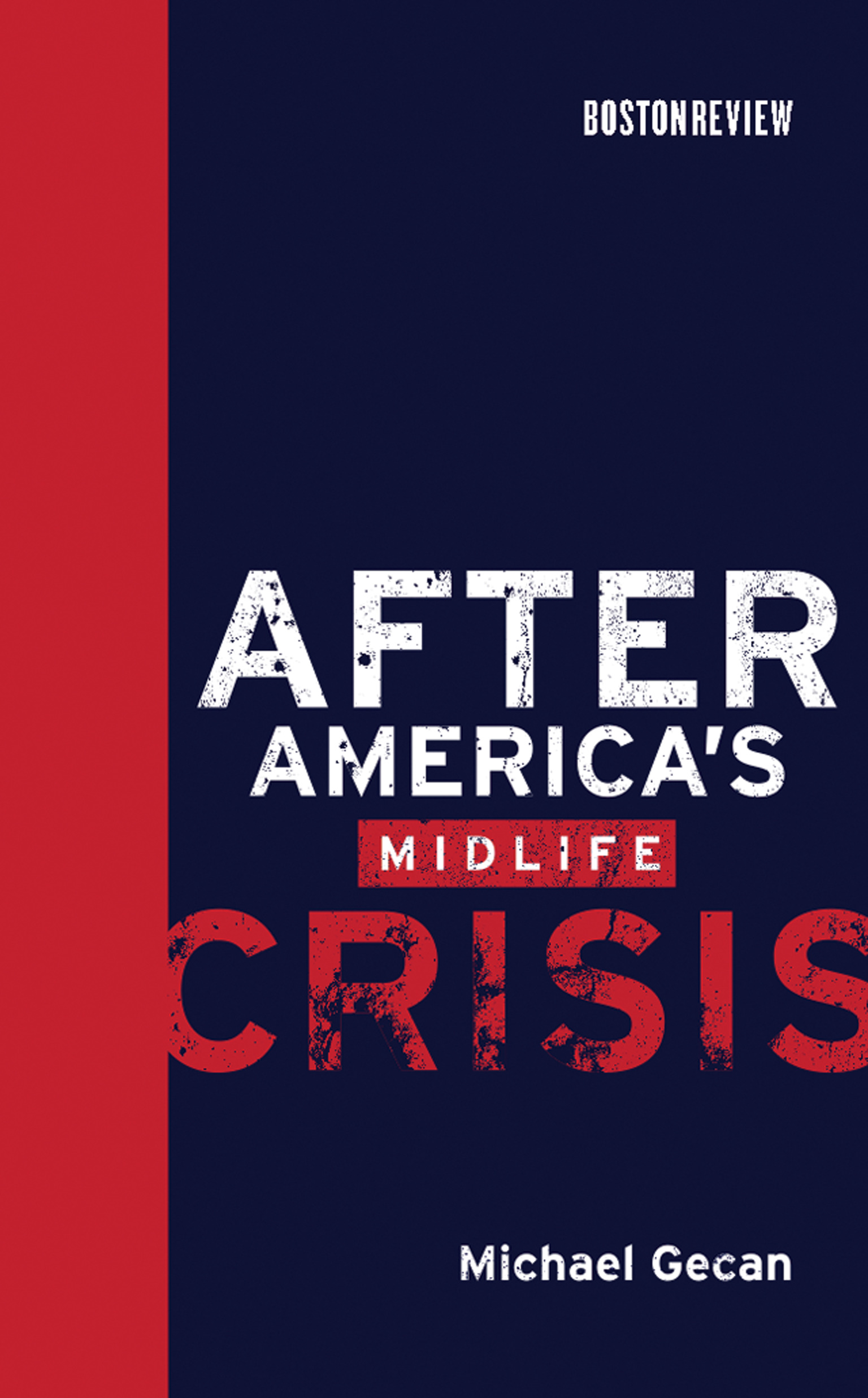
After America's Midlife Crisis A longtime community organizer outlines a way to reverse the fifty-year decline in social mobility and economic progress. Michael Gecan, a longtime community organizer, offers in this book a disturbing conclusion: the kinds of problems that began to afflict large cities in the 1970s have now spread to the suburbs and beyond. The institutional cornerstones of American life are on an extended decline. No longer young, no longer without limitations or constraints, the country is facing a midlife crisis. Drawing on personal experiences and the stories of communities in Illinois, New York, and other areas, Gecan draws a vivid picture of civic, political, and religious institutions in trouble, from suburban budget crises to failing public schools. Gecan shows that the loss of social capital has followed closely upon institutional failure. He looks in particular at the two main support systems of social mobility and economic progress for the majority of working poor Americans in the first half of the last century—the Roman Catholic school system and the American public high school. As these institutions that generated social progress have faded, those depending on social regression—prisons, jails, and detention centers—have thrived. Can we reverse the trends? Gecan offers hope and a direction forward. He calls on national and local leadership to shed old ways of thinking and face new realities, which include not only the substantial costs of change but also its considerable benefits. Only then will we enjoy the next rich phase of our local and national life. POLITICAL SCIENCE,Public Policy,City Planning & Urban Development
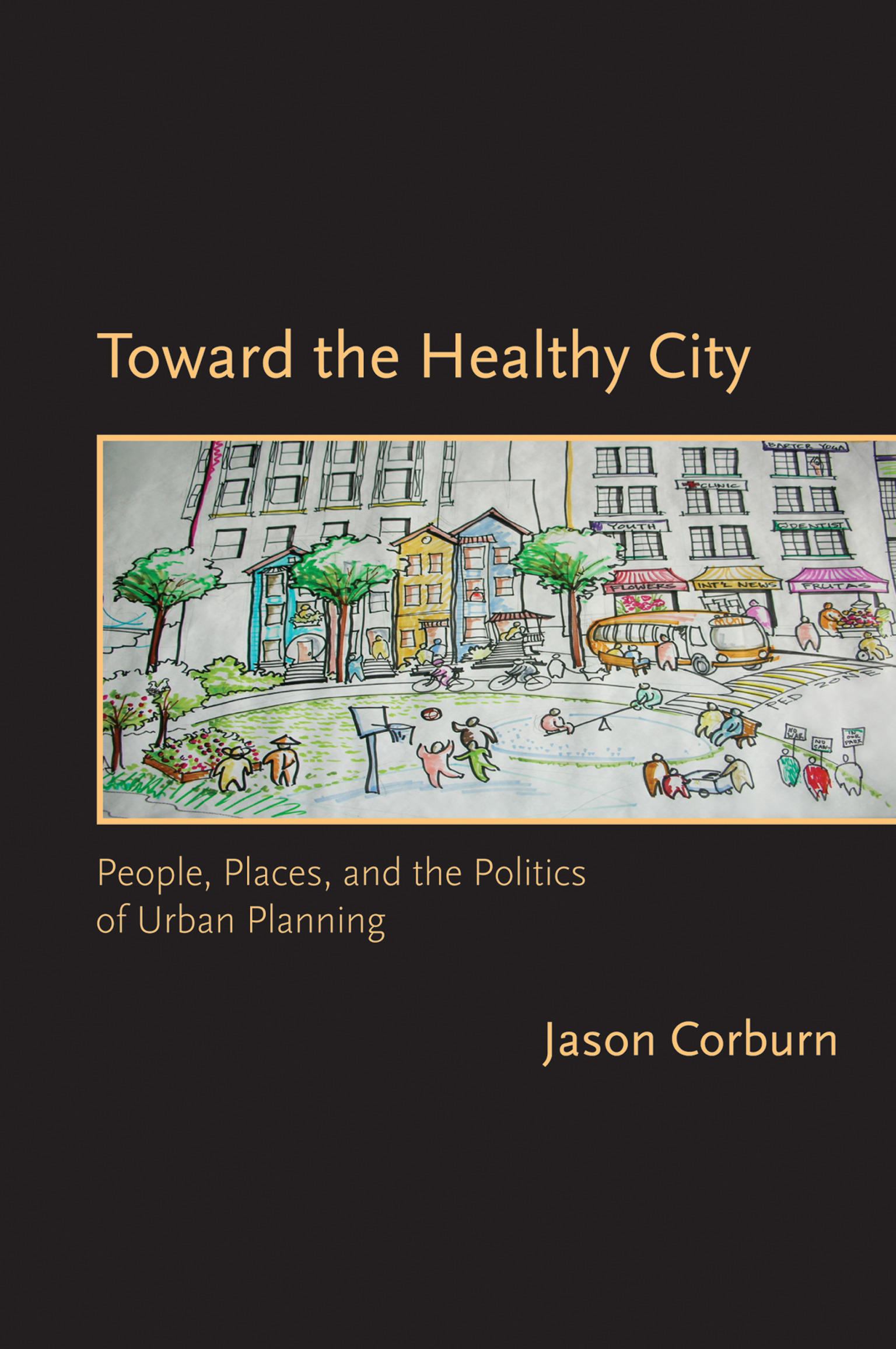
Toward the Healthy City A call to reconnect the fields of urban planning and public health that offers a new decision-making framework for healthy city planning. In distressed urban neighborhoods where residential segregation concentrates poverty, liquor stores outnumber supermarkets, toxic sites are next to playgrounds, and more money is spent on prisons than schools, residents also suffer disproportionately from disease and premature death. Recognizing that city environments and the planning processes that shape them are powerful determinants of population health, urban planners today are beginning to take on the added challenge of revitalizing neglected urban neighborhoods in ways that improve health and promote greater equity. In Toward the Healthy City, Jason Corburn argues that city planning must return to its roots in public health and social justice. The first book to provide a detailed account of how city planning and public health practices can reconnect to address health disparities, Toward the Healthy City offers a new decision-making framework called “healthy city planning” that reframes traditional planning and development issues and offers a new scientific evidence base for participatory action, coalition building, and ongoing monitoring. To show healthy city planning in action, Corburn examines collaborations between government agencies and community coalitions in the San Francisco Bay area, including efforts to link environmental justice, residents' chronic illnesses, housing and real estate development projects, and planning processes with public health. Initiatives like these, Corburn points out, go well beyond recent attempts by urban planners to promote public health by changing the design of cities to encourage physical activity. Corburn argues for a broader conception of healthy urban governance that addresses the root causes of health inequities. POLITICAL SCIENCE,Public Policy,City Planning & Urban Development

The Making of Grand Paris A critical examination of metropolitan planning in Paris—the “Grand Paris” initiative—and the building of today's networked global city. In 2007 the French government announced the “Grand Paris” initiative. This ambitious project reimagined the Paris region as integrated, balanced, global, sustainable, and prosperous. Metropolitan solidarity would unite divided populations; a new transportation system, the Grand Paris Express, would connect the affluent city proper with the low-income suburbs; streamlined institutions would replace fragmented governance structures. Grand Paris is more than a redevelopment plan; it is a new paradigm for urbanism. In this first English-language examination of Grand Paris, Theresa Enright offers a critical analysis of the early stages of the project, considering whether it can achieve its twin goals of economic competitiveness and equality. Enright argues that by orienting the city around growth and marketization, Grand Paris reproduces the social and spatial hierarchies it sets out to address. For example, large expenditures for the Grand Paris Express are made not for the public good but to increase the attractiveness of the region to private investors, setting off a real estate boom, encouraging gentrification, and leaving many residents still unable to get from here to there. Enright describes Grand Paris as an example of what she calls “grand urbanism,” large-scale planning that relies on infrastructural megaprojects to reconfigure urban regions in pursuit of speculative redevelopment. Democracy and equality suffer under processes of grand urbanism. Given the logic of commodification on which Grand Paris is based, these are likely to suffer as the project moves forward. POLITICAL SCIENCE,Public Policy,City Planning & Urban Development
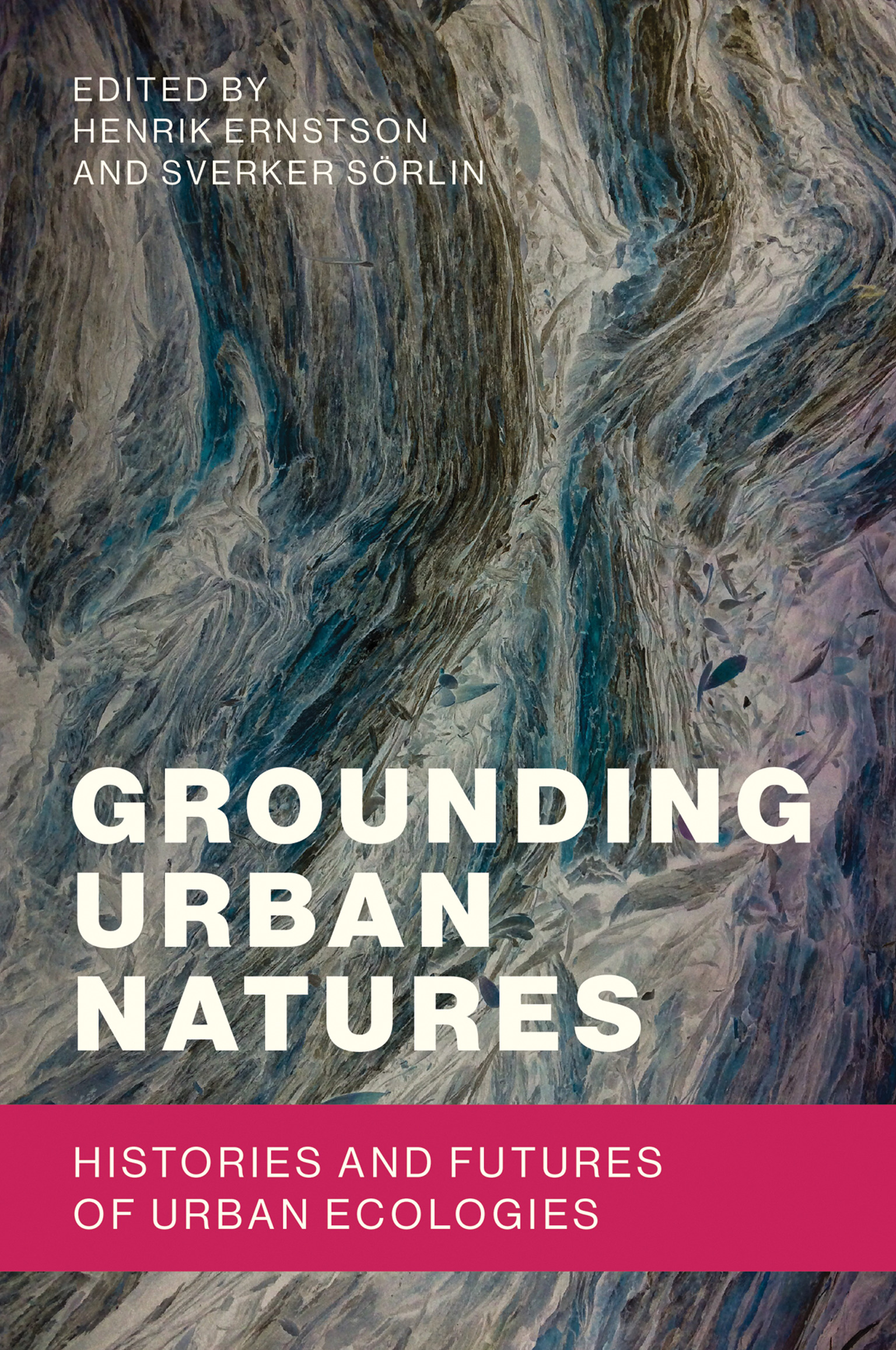
Grounding Urban Natures Case studies from cities on five continents demonstrate the advantages of thinking comparatively about urban environments. The global discourse around urban ecology tends to homogenize and universalize, relying on such terms as “smart cities,” “eco-cities,” and “resilience,” and proposing a “science of cities” based largely on information from the Global North. Grounding Urban Natures makes the case for the importance of place and time in understanding urban environments. Rather than imposing a unified framework on the ecology of cities, the contributors use a variety of approaches across a range of of locales and timespans to examine how urban natures are part of—and are shaped by—cities and urbanization. Grounding Urban Natures offers case studies from cities on five continents that demonstrate the advantages of thinking comparatively about urban environments. The contributors consider the diversity of urban natures, analyzing urban ecologies that range from the coastal delta of New Orleans to real estate practices of the urban poor in Lagos. They examine the effect of popular movements on the meanings of urban nature in cities including San Francisco, Delhi, and Berlin. Finally, they explore abstract urban planning models and their global mobility, examining real-world applications in such cities as Cape Town, Baltimore, and the Chinese “eco-city” Yixing. Contributors Martín Ávila, Amita Baviskar, Jia-Ching Chen, Henrik Ernstson, James Evans, Lisa M. Hoffman, Jens Lachmund, Joshua Lewis, Lindsay Sawyer, Sverker Sörlin, Anne Whiston Spirn, Lance van Sittert, Richard A. Walker POLITICAL SCIENCE,Public Policy,City Planning & Urban Development
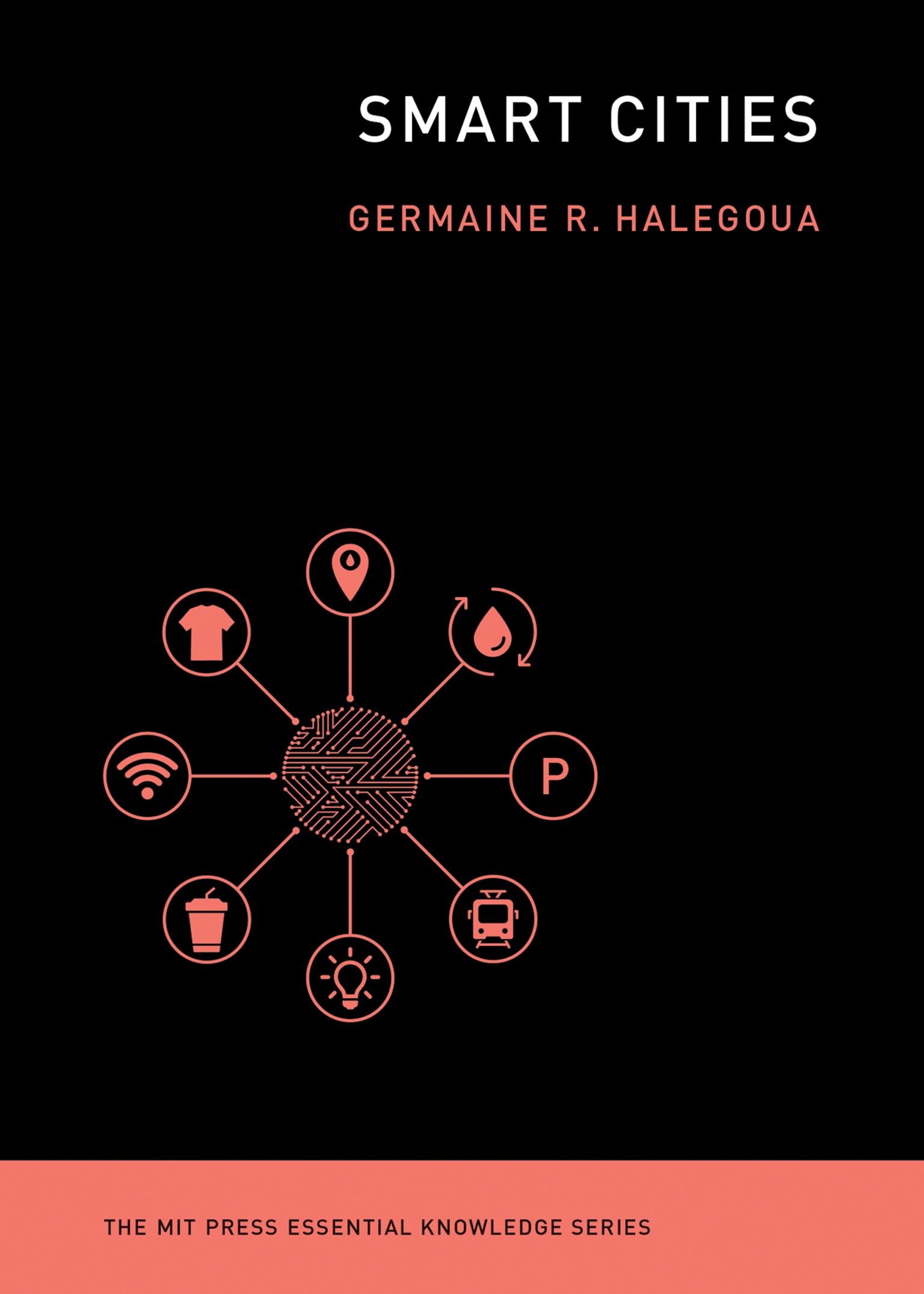
Smart Cities Key concepts, definitions, examples, and historical contexts for understanding smart cities, along with discussions of both drawbacks and benefits of this approach to urban problems. Over the past ten years, urban planners, technology companies, and governments have promoted smart cities with a somewhat utopian vision of urban life made knowable and manageable through data collection and analysis. Emerging smart cities have become both crucibles and showrooms for the practical application of the Internet of Things, cloud computing, and the integration of big data into everyday life. Are smart cities optimized, sustainable, digitally networked solutions to urban problems? Or are they neoliberal, corporate-controlled, undemocratic non-places? This volume in the MIT Press Essential Knowledge series offers a concise introduction to smart cities, presenting key concepts, definitions, examples, and historical contexts, along with discussions of both the drawbacks and the benefits of this approach to urban life. After reviewing current terminology and justifications employed by technology designers, journalists, and researchers, the book describes three models for smart city development—smart-from-the-start cities, retrofitted cities, and social cities—and offers examples of each. It covers technologies and methods, including sensors, public wi-fi, big data, and smartphone apps, and discusses how developers conceive of interactions among the built environment, technological and urban infrastructures, citizens, and citizen engagement. Throughout, the author—who has studied smart cities around the world—argues that smart city developers should work more closely with local communities, recognizing their preexisting relationship to urban place and realizing the limits of technological fixes. Smartness is a means to an end: improving the quality of urban life. POLITICAL SCIENCE,Public Policy,City Planning & Urban Development

What a City Is For An investigation into gentrification and displacement, focusing on the case of Portland, Oregon's systematic dispersal of black residents from its Albina neighborhood. Portland, Oregon, is one of the most beautiful, livable cities in the United States. It has walkable neighborhoods, bike lanes, low-density housing, public transportation, and significant green space—not to mention craft-beer bars and locavore food trucks. But liberal Portland is also the whitest city in the country. This is not circumstance; the city has a long history of officially sanctioned racialized displacement that continues today. Over the last two and half decades, Albina—the one major Black neighborhood in Portland—has been systematically uprooted by market-driven gentrification and city-renewal policies. African Americans in Portland were first pushed into Albina and then contained there through exclusionary zoning, predatory lending, and racist real estate practices. Since the 1990s, they've been aggressively displaced—by rising housing costs, developers eager to get rid of low-income residents, and overt city policies of gentrification. Displacement and dispossessions are convulsing cities across the globe, becoming the dominant urban narratives of our time. In What a City Is For, Matt Hern uses the case of Albina, as well as similar instances in New Orleans and Vancouver, to investigate gentrification in the twenty-first century. In an engaging narrative, effortlessly mixing anecdote and theory, Hern questions the notions of development, private property, and ownership. Arguing that home ownership drives inequality, he wants us to disown ownership. How can we reimagine the city as a post-ownership, post-sovereign space? Drawing on solidarity economics, cooperative movements, community land trusts, indigenous conceptions of alternative sovereignty, the global commons movement, and much else, Hern suggests repudiating development in favor of an incrementalist, non-market-driven unfolding of the city. POLITICAL SCIENCE,Public Policy,City Planning & Urban Development

Sequel to Suburbia How the decentralized, automobile-oriented, and fuel-consuming model of American suburban development might change. In the years after World War II, a distinctly American model for suburban development emerged. The expansive rings of outer suburbs that formed around major cities were decentralized and automobile oriented, an embodiment of America's postwar mass-production, mass-consumption economy. But alternate models for suburbia, including “transit-oriented development,” “smart growth,” and “New Urbanism,” have inspired critiques of suburbanization and experiments in post-suburban ways of living. In Sequel to Suburbia, Nicholas Phelps considers the possible post-suburban future, offering historical and theoretical context as well as case studies of transforming communities. Phelps first locates these outer suburban rings within wider metropolitan spaces, describes the suburbs as a “spatial fix” for the postwar capitalist economy, and examines the political and governmental obstacles to reworking suburban space. He then presents three glimpses of post-suburban America, looking at Kendall-Dadeland (in Miami-Dade County, Florida), Tysons Corner (in Fairfax County, Virginia), and Schaumburg, Illinois (near Chicago). He shows Kendall-Dadeland to be an isolated New Urbanism success; describes the re-planning of Tysons Corner to include a retrofitted central downtown area; and examines Schaumburg's position as a regional capital for Chicago's northwest suburbs. As these cases show, the reworking of suburban space and the accompanying political process will not be left to a small group of architects, planners, and politicians. Post-suburban politics will have to command the approval of the residents of suburbia. POLITICAL SCIENCE,Public Policy,City Planning & Urban Development
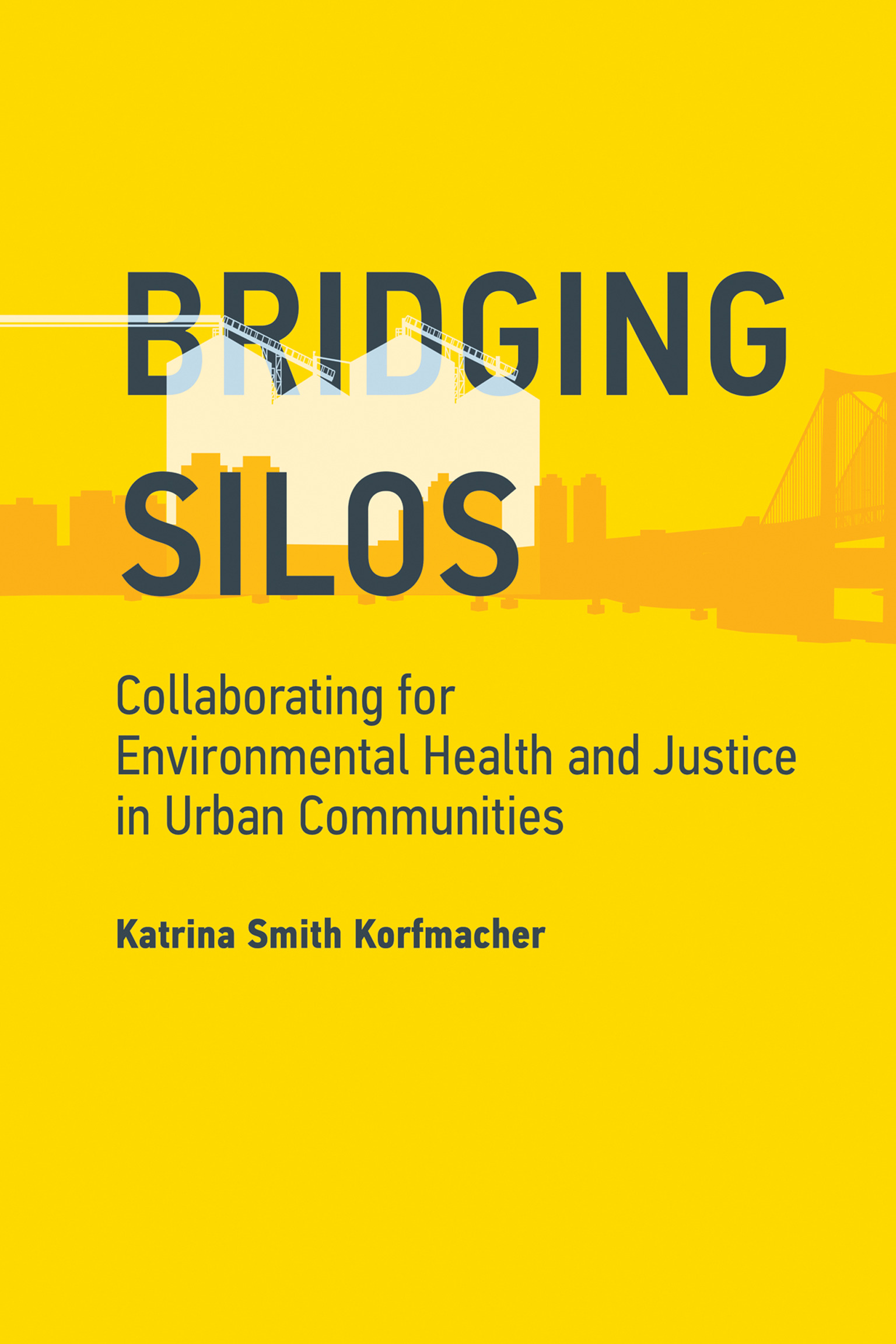
Bridging Silos How communities can collaborate across systems and sectors to address environmental health disparities; with case studies from Rochester, New York; Duluth, Minnesota; and Southern California. Low-income and marginalized urban communities often suffer disproportionate exposure to environmental hazards, leaving residents vulnerable to associated health problems. Community groups, academics, environmental justice advocates, government agencies, and others have worked to address these issues, building coalitions at the local level to change the policies and systems that create environmental health inequities. In Bridging Silos, Katrina Smith Korfmacher examines ways that communities can collaborate across systems and sectors to address environmental health disparities, with in-depth studies of three efforts to address long-standing environmental health issues: childhood lead poisoning in Rochester, New York; unhealthy built environments in Duluth, Minnesota; and pollution related to commercial ports and international trade in Southern California. All three efforts were locally initiated, driven by local stakeholders, and each addressed issues long known to the community by reframing an old problem in a new way. These local efforts leveraged resources to impact community change by focusing on inequities in environmental health, bringing diverse kinds of knowledge to bear, and forging new connections among existing community, academic, and government groups. Korfmacher explains how the once integrated environmental and public health management systems had become separated into self-contained “silos,” and compares current efforts to bridge these separations to the development of ecosystem management in the 1990s. Community groups, government agencies, academic institutions, and private institutions each have a role to play, but collaborating effectively requires stakeholders to appreciate their partners' diverse incentives, capacities, and constraints. POLITICAL SCIENCE,Public Policy,City Planning & Urban Development

Inventing Future Cities How we can invent—but not predict—the future of cities. We cannot predict future cities, but we can invent them. Cities are largely unpredictable because they are complex systems that are more like organisms than machines. Neither the laws of economics nor the laws of mechanics apply; cities are the product of countless individual and collective decisions that do not conform to any grand plan. They are the product of our inventions; they evolve. In Inventing Future Cities, Michael Batty explores what we need to understand about cities in order to invent their future. Batty outlines certain themes—principles—that apply to all cities. He investigates not the invention of artifacts but inventive processes. Today form is becoming ever more divorced from function; information networks now shape the traditional functions of cities as places of exchange and innovation. By the end of this century, most of the world's population will live in cities, large or small, sometimes contiguous, and always connected; in an urbanized world, it will be increasingly difficult to define a city by its physical boundaries. Batty discusses the coming great transition from a world with few cities to a world of all cities; argues that future cities will be defined as clusters in a hierarchy; describes the future “high-frequency,” real-time streaming city; considers urban sprawl and urban renewal; and maps the waves of technological change, which grow ever more intense and lead to continuous innovation—an unending process of creative destruction out of which future cities will emerge. POLITICAL SCIENCE,Public Policy,City Planning & Urban Development
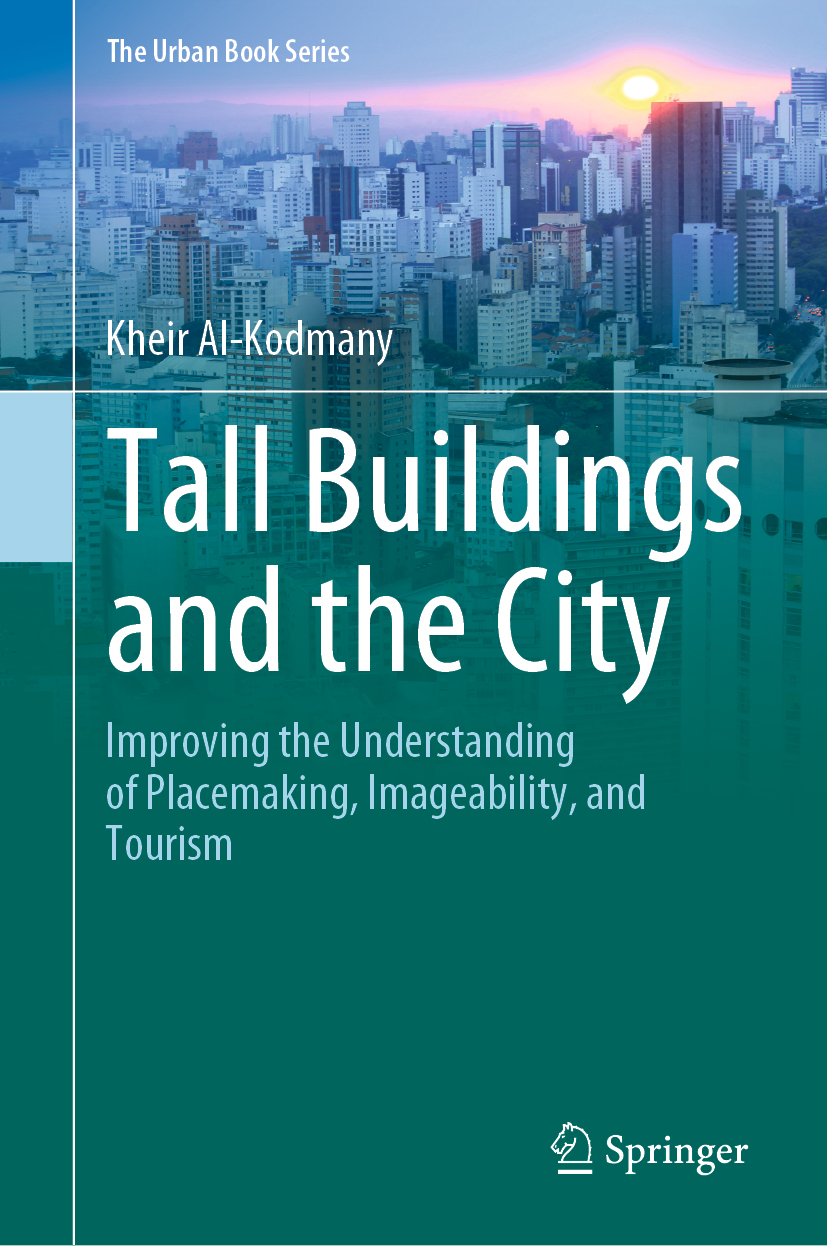
Tall Buildings and the City The chaotic proliferation of skyscrapers in many cities around the world is contributing to a decline in placemaking. This book examines the role of skyscrapers and open spaces in promoting placemaking in the city of Chicago. Chicago’s skyscrapers tell an epic story of transformative architectural design, innovative engineering solutions, and bold entrepreneurial spirit. The city’s public plazas and open spaces attract visitors, breathe life, and bring balance into the cityscape. Using locational data from social media platforms, including Twitter, Facebook, and Instagram, along with imagery from Google Earth, fieldwork, direct observations, in-depth surveys, and the combined insights from architectural and urban design literature, this study reveals the roles that socio-spatial clusters of skyscrapers, public spaces, architecture, and artwork play to enhance placemaking in Chicago. The study illustrates how Chicago, as the birthplace of skyscrapers, remains a leading city in tall building integration and innovation. Focusing on some of the finest urban places in America, including the Chicago River, the Magnificent Mile, and the Chicago Loop, the book offers meaningful architectural and urban design lessons that are transferable to emerging skyscraper cities around the globe. POLITICAL SCIENCE,Public Policy,City Planning & Urban Development

The Bronx The rise and fall and rise of the South Bronx: “A thoughtful story of urbanization in a place that most Americans know only stereotypically.†—American Historical Review Home to the New York Yankees, the Bronx Zoo, and the Grand Concourse, the Bronx was at one time a haven for upwardly mobile second-generation immigrants eager to leave the crowded tenements of Manhattan in pursuit of the American dream. Once hailed as a “wonder borough†of beautiful homes, parks, and universities, the Bronx became—during the 1960s and 1970s—a national symbol of urban deterioration. Thriving neighborhoods that had long been home to generations of families dissolved under waves of arson, crime, and housing abandonment, turning blocks of apartment buildings into gutted, graffiti-covered shells and empty, trash-filled lots. In this revealing history of the Bronx, Evelyn Gonzalez describes how the once-infamous New York City borough underwent one of the most successful and inspiring community revivals in American history. From its beginnings as a loose cluster of commuter villages to its current status as a densely populated home for New York’s growing and increasingly diverse African American and Hispanic populations, this book shows how the Bronx interacted with and was affected by the rest of New York City as it grew from a small colony on the tip of Manhattan into a sprawling metropolis. This is the story of the clattering of elevated subways and the cacophony of crowded neighborhoods, the heady optimism of industrial progress and the despair of economic recession, and the vibrancy of ethnic cultures and the resilience of local grassroots coalitions crucial to the borough’s rejuvenation. “Gonzalez’s reporting and research are excellent, and scholars will appreciate the extensive bibliography.†—Library Journal POLITICAL SCIENCE,Public Policy,City Planning & Urban Development
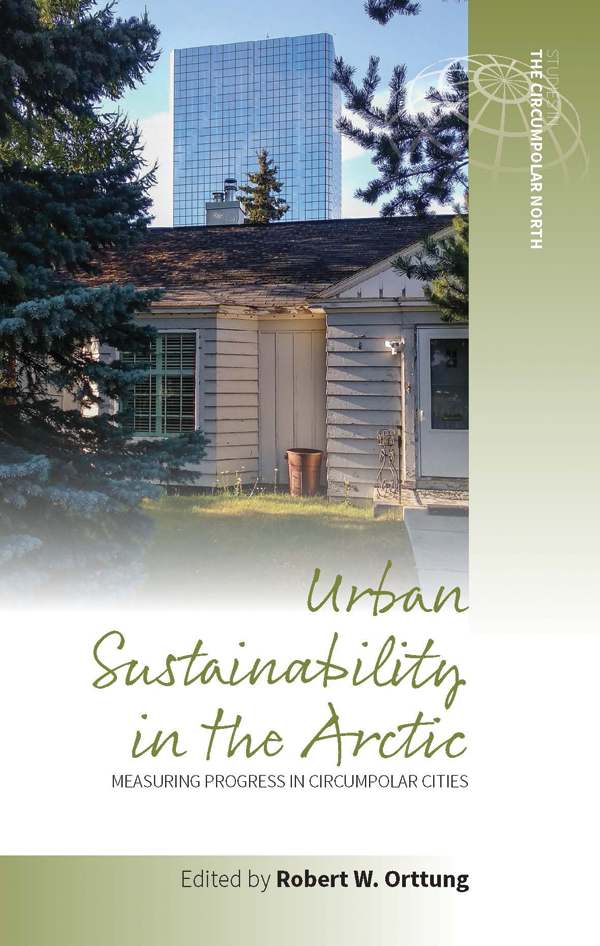
Urban Sustainability in the Arctic Urban Sustainability in the Arctic advances our understanding of cities in the far north by applying elements of the international standard for urban sustainability (ISO 37120) to numerous Arctic cities. In delivering rich material about northern cities in Alaska, Canada, and Russia, the book examines how well the ISO 37120 measures sustainability and how well it applies in northern conditions. In doing so, it links the Arctic cities into a broader conversation about urban sustainability more generally. POLITICAL SCIENCE,Public Policy,City Planning & Urban Development

Hate Spin How right-wing political entrepreneurs around the world use religious offense—both given and taken—to mobilize supporters and marginalize opponents. In the United States, elements of the religious right fuel fears of an existential Islamic threat, spreading anti-Muslim rhetoric into mainstream politics. In Indonesia, Muslim absolutists urge suppression of churches and minority sects, fostering a climate of rising intolerance. In India, Narendra Modi's radical supporters instigate communal riots and academic censorship in pursuit of their Hindu nationalist vision. Outbreaks of religious intolerance are usually assumed to be visceral and spontaneous. But in Hate Spin, Cherian George shows that they often involve sophisticated campaigns manufactured by political opportunists to mobilize supporters and marginalize opponents. Right-wing networks orchestrate the giving of offense and the taking of offense as instruments of identity politics, exploiting democratic space to promote agendas that undermine democratic values. George calls this strategy “hate spin”—a double-sided technique that combines hate speech (incitement through vilification) with manufactured offense-taking (the performing of righteous indignation). It is deployed in societies as diverse as Buddhist Myanmar and Orthodox Christian Russia. George looks at the world's three largest democracies, where intolerant groups within India's Hindu right, America's Christian right, and Indonesia's Muslim right are all accomplished users of hate spin. He also shows how the Internet and Google have opened up new opportunities for cross-border hate spin. George argues that governments must protect vulnerable communities by prohibiting calls to action that lead directly to discrimination and violence. But laws that try to protect believers' feelings against all provocative expression invariably backfire. They arm hate spin agents' offense-taking campaigns with legal ammunition. Anti-discrimination laws and a commitment to religious equality will protect communities more meaningfully than misguided attempts to insulate them from insult. POLITICAL SCIENCE,Public Policy,Communication Policy
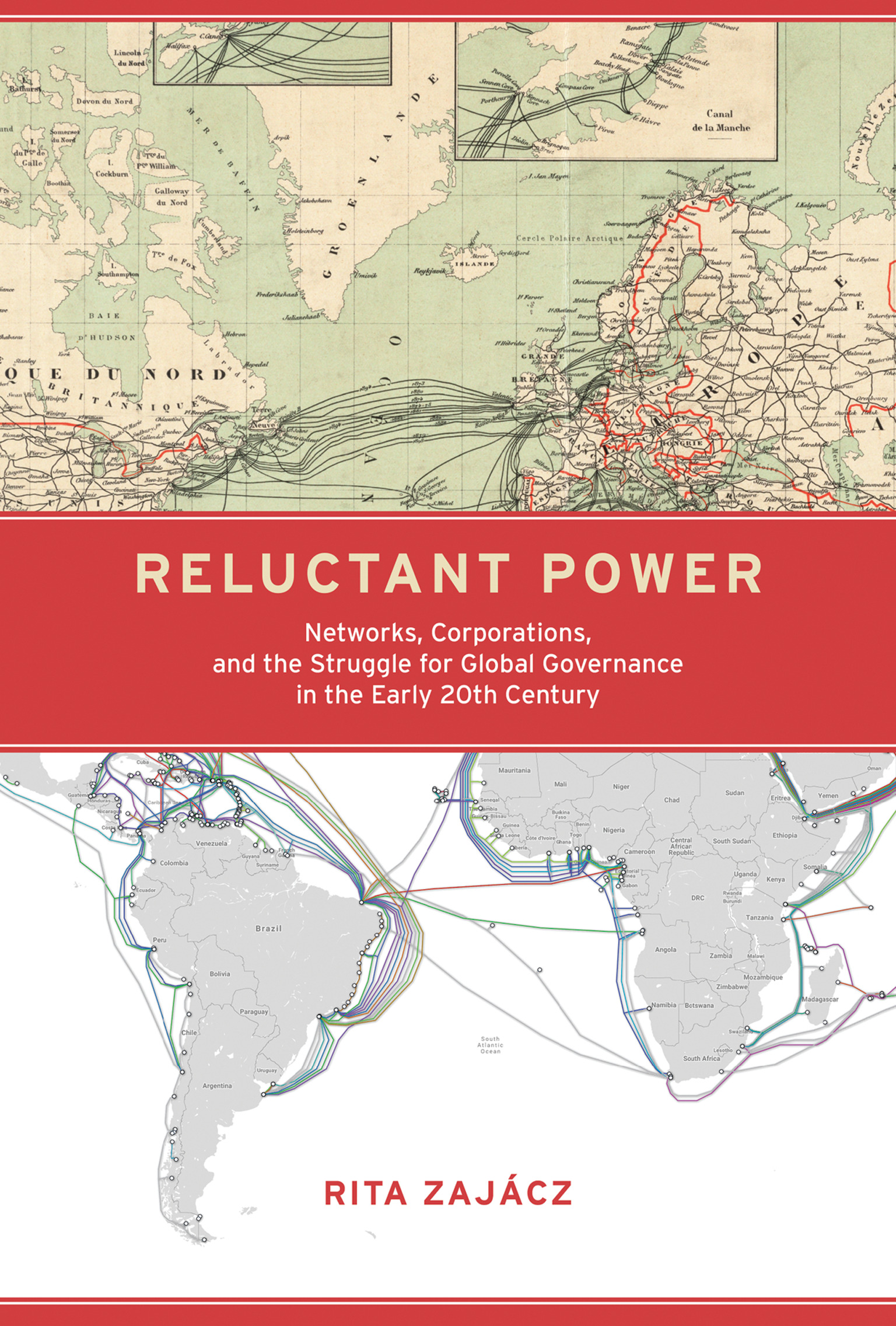
Reluctant Power How early twentieth-century American policymakers sought to gain control over radiotelegraphy networks in an effort to advance the global position of the United States. In Reluctant Power, Rita Zajácz examines how early twentieth century American policymakers sought to gain control over radiotelegraphy networks in an effort to advance the global position of the United States. Doing so, she develops an analytical framework for understanding the struggle for network control that can be applied not only to American attempts to establish a global radio network in the early twentieth century but also to current US efforts to retain control of the internet. In the late nineteenth century, Britain was seen to control both the high seas and the global cable communication network under the sea. By the turn of the twentieth century, Britain's geopolitical rivals, including the United States, looked to radiotelegraphy that could circumvent Britain's dominance. Zajácz traces policymakers' attempts to grapple with both a new technology—radiotelegraphy—and a new corporate form: the multinational corporation, which managed the network and acted as a crucial intermediary. She argues that both foreign policy and domestic radio legislation were shaped by the desire to harness radiotelegraphy for geopolitical purposes and reveals how communication policy and aspects of the American legal system adjusted to the demands of a rising power. The United States was a reluctant power during the early twentieth century, because policymakers were unsure that companies headquartered in the United States were sufficiently American and doubted that their strategies served the national interest. POLITICAL SCIENCE,Public Policy,Communication Policy

Chavs In modern Britain, the working class has become an object of fear and ridicule. From Little Britain’s Vicky Pollard to the demonization of Jade Goody, media and politicians alike dismiss as feckless, criminalized and ignorant a vast, underprivileged swathe of society whose members have become stereotyped by one, hate-filled word: chavs. In this acclaimed investigation, Owen Jones explores how the working class has gone from “salt of the earth” to “scum of the earth.” Exposing the ignorance and prejudice at the heart of the chav caricature, he portrays a far more complex reality. The chav stereotype, he argues, is used by governments as a convenient figleaf to avoid genuine engagement with social and economic problems and to justify widening inequality. Based on a wealth of original research, Chavs is a damning indictment of the media and political establishment and an illuminating, disturbing portrait of inequality and class hatred in modern Britain. This updated edition includes a new chapter exploring the causes and consequences of the UK riots in the summer of 2011. POLITICAL SCIENCE,Public Policy,Cultural Policy
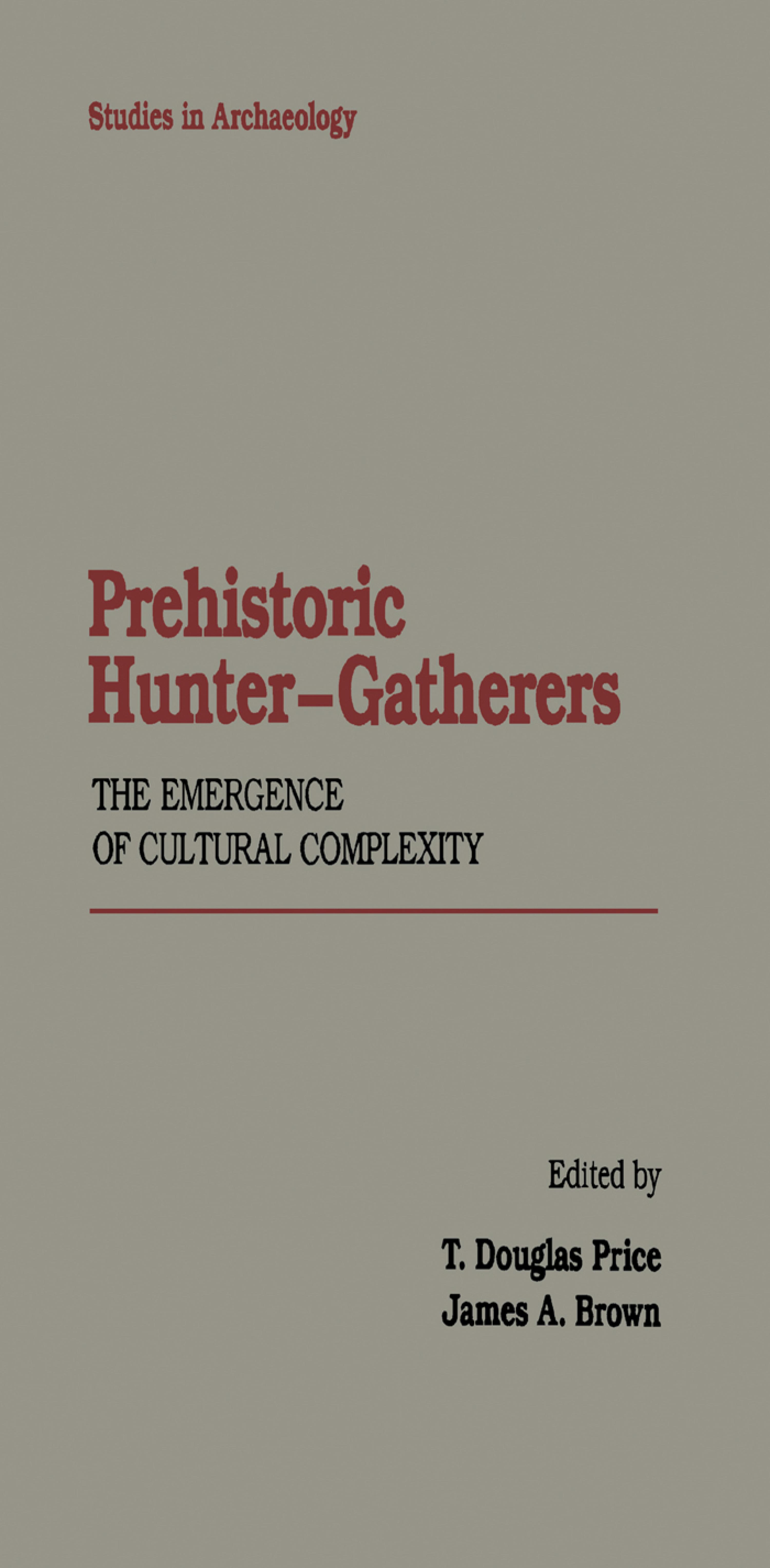
Prehistoric Hunter-Gatherers Prehistoric Hunters-Gatherers : The Emergence of Cultural Complexity POLITICAL SCIENCE,Public Policy,Cultural Policy
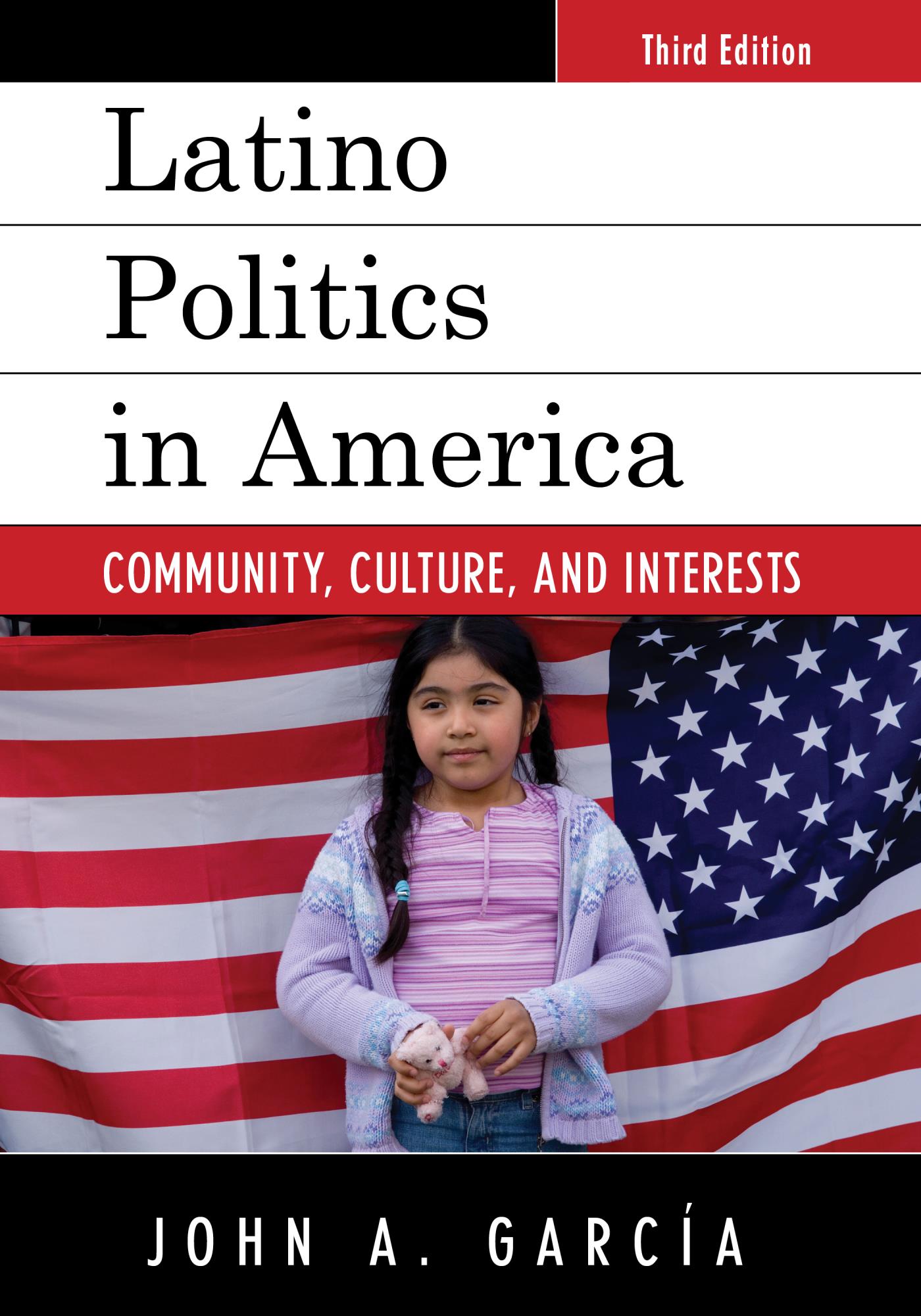
Latino Politics in America Latino Politics in America: Community, Culture, and Interests provides an in-depth look at how the various sub-groups of the Latino community influence the political landscape. In this third edition, Garcia discusses how topics such as voting, immigration, Latinos’ own mobilization efforts, partisanship, and political engagement are all impacted by Latino leadership, activated communities, and advocacy groups. POLITICAL SCIENCE,Public Policy,Cultural Policy

Sex Matters Author of the New York Times bestseller Useful Idiots and popular columnist Mona Charen takes a close, reasoned look at the aggressive feminist agenda undermining the success and happiness of men and women across the country In this smart, deeply necessary critique, Mona Charen unpacks the ways feminism fails us at home, in the workplace, and in our personal relationships--by promising that we can have it all, do it all, and be it all. Here, she upends the feminist agenda and the liberal conversation surrounding women's issues by asking tough and crucial questions, such as: • Did women's full equality require the total destruction of the nuclear family? • Did it require a sexual revolution that would dismantle traditions of modesty, courtship, and fidelity that had characterized relations between the sexes for centuries? • Did it cause the broken dating culture and the rape crisis on our college campuses? • Did it require war between the sexes that would deem men the "enemy" of women? • Have the strides of feminism made women happier in their home and work life. (The answer is No.) Sex Matters tracks the price we have paid for denying sex differences and stoking the war of the sexes--family breakdown, declining female happiness, aimlessness among men, and increasing inequality. Marshaling copious social science research as well as her own experience as a professional as well as a wife and mother, Mona Charen calls for a sexual ceasefire for the sake of women, men, and children. POLITICAL SCIENCE,Public Policy,Cultural Policy

Tell Your Children In “a brilliant antidote to all the…false narratives about pot†(American Thinker) , an award-winning author and former New York Times reporter reveals the link between teenage marijuana use and mental illness, and a hidden epidemic of violence caused by the drug—facts the media have ignored as the United States rushes to legalize cannabis. Recreational marijuana is now legal in nine states. Advocates argue cannabis can help everyone from veterans to cancer sufferers. But legalization has been built on myths—that marijuana arrests fill prisons; that most doctors want to use cannabis as medicine; that it can somehow stem the opiate epidemic; that it is beneficial for mental health. In this meticulously reported book, Alex Berenson, a former New York Times reporter, explodes those myths, explaining that almost no one is in prison for marijuana; a tiny fraction of doctors write most authorizations for medical marijuana, mostly for people who have already used; and marijuana use is linked to opiate and cocaine use. Most of all, THC—the chemical in marijuana responsible for the drug’s high—can cause psychotic episodes. “Alex Berenson has a reporter’s tenacity, a novelist’s imagination, and an outsider’s knack for asking intemperate questions†(Malcolm Gladwell, The New Yorker), as he ranges from the London institute that is home to the scientists who helped prove the cannabis-psychosis link to the Colorado prison where a man now serves a thirty-year sentence after eating a THC-laced candy bar and killing his wife. He sticks to the facts, and they are devastating. With the US already gripped by one drug epidemic, Tell Your Children is a “well-written treatise†(Publishers Weekly) that “takes a sledgehammer to the promised benefits of marijuana legalization, and cannabis enthusiasts are not going to like it one bit†(Mother Jones). POLITICAL SCIENCE,Public Policy,Cultural Policy
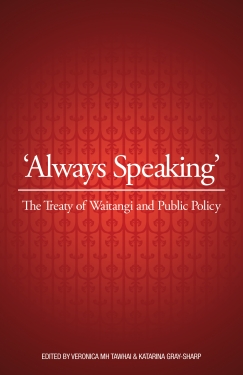
Always Speaking This is a collection of papers that examine the current place of the Treaty of Watangi in core public policy areas. The authors analyse the tensions and dynamics in the relationship between Maori and the Crown in their areas of expertise, detail the key challenges being faced, and provide insights on how these can be overcome. The policy areas covered in the collection span the environment, Maori and social development, health, broadcasting, the Maori language, prison and the courts, local government, research, science and technology, culture and heritage, foreign affairs, women's issues, labour, youth, education, economics, housing and the electoral system. POLITICAL SCIENCE,Public Policy,Cultural Policy
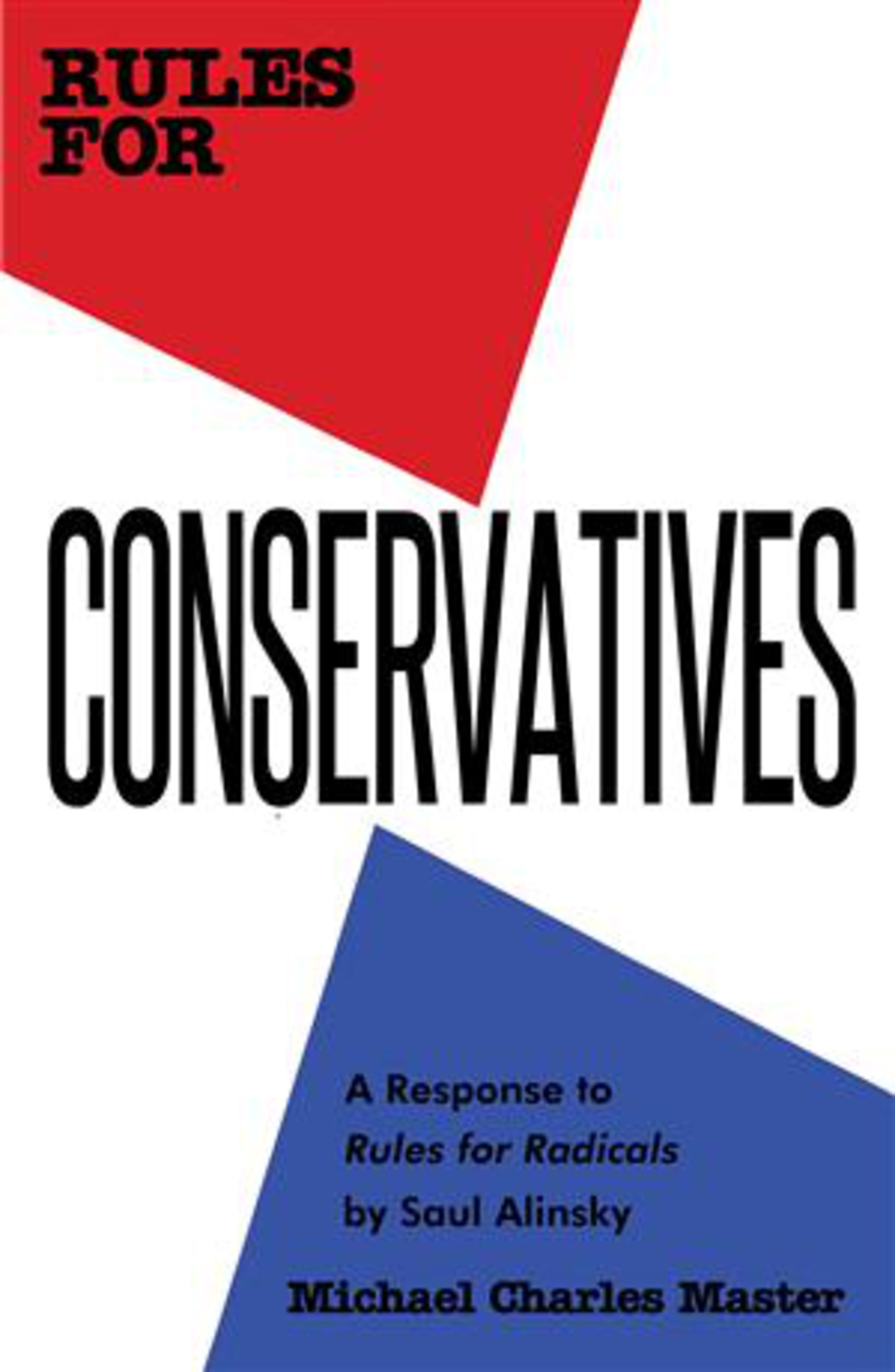
Rules for Conservatives Saul Alinsky wrote Rules for Radicals 40 years ago as instructions on how to seize power. He was the original community organizer who documented how to organize others to provide power to the organizers. Alinsky was an instigator of class warfare and of the culture war. He taught liberals how to divide America by organizing communities to seize power. Because of those who practiced those rules, America is suffering. Every problem that we Americans face today can be traced back to compromises with liberal radical leaders. As it defined the rules that radicals should use to implement socialism and gain more control of governments, Rules for Conservatives defines the rules that conservatives should use to stop this incremental takeover by liberals. The Tea Party movement is determined to cut the tax burden on Americans. With decreased tax revenues, governments will have to shrink and liberals will lose power. Rules for Conservatives is the playbook for all conservatives and all Tea Party people to save America from liberal community organizers. POLITICAL SCIENCE,Public Policy,Cultural Policy

The Flipside of Feminism Forty years have passed since the so-called women's movement claimed to liberate women from preconceived notions of what it means to be female - and the results are in. The latest statistics show that as women have gained more freedom, more education, and more power, they have become less happy. In The Flipside of Feminism, Suzanne Venker and Phyllis Schlafly provide readers with a new view of women in America - casting off the ideology that preaches faux empowerment and liberation from men and marriage. Their book demonstrates that conservative women are, in fact, the most liberated women in America and the folks to whom young people should be turning for advice. Their confident and rational approach to the battle of the sexes is precisely what America needs. POLITICAL SCIENCE,Public Policy,Cultural Policy

Eurovision and Australia This book investigates Australia’s relationship with the Eurovision Song Contest over time and place, from its first screening on SBS in 1983 to Australia's inaugural national selection in 2019. Beginning with an overview of Australia’s Eurovision history, the contributions explore the contest’s role in Australian political participation and international relations; its significance for Australia’s diverse communities, including migrants and the LGBTQIA+ community; racialised and gendered representations of Australianness; changing ideas of liveness in watching the event; and a reflection on teaching Australia’s first undergraduate course dedicated to the Eurovision Song Contest. The collection brings together a group of scholar-fans from a variety of interdisciplinary perspectives — including history, politics, cultural studies, performance studies, and musicology — to explore Australia’s transition from observer to participant in the first thirty-six years of its love affair with the Eurovision Song Contest. POLITICAL SCIENCE,Public Policy,Cultural Policy
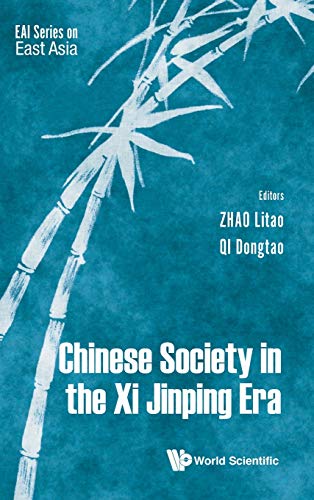
Chinese Society In The Xi Jinping Era As China has become the world's second largest economy and risen rapidly amid various internal and external challenges, its profound social transformation and changing social policies are seemingly receiving inadequate attention from both academic and policy communities, especially in the Xi Jinping era since 2013. After decades of development, new social values, behaviours and organisations have emerged in China. Social changes and unresolved social issues are demanding for policy attention and proper governance.This book studies the important aspects of China's social transformation, policy and governance in recent years, including social stability maintenance, education, social media, industrial de-capacity and lay-off campaign, ethnic minority and ethnic policy, elderly care, poverty reduction and social governance. It will enable readers to have a better understanding of China's most important and pressing social issues and relevant social policies. POLITICAL SCIENCE,Public Policy,Cultural Policy
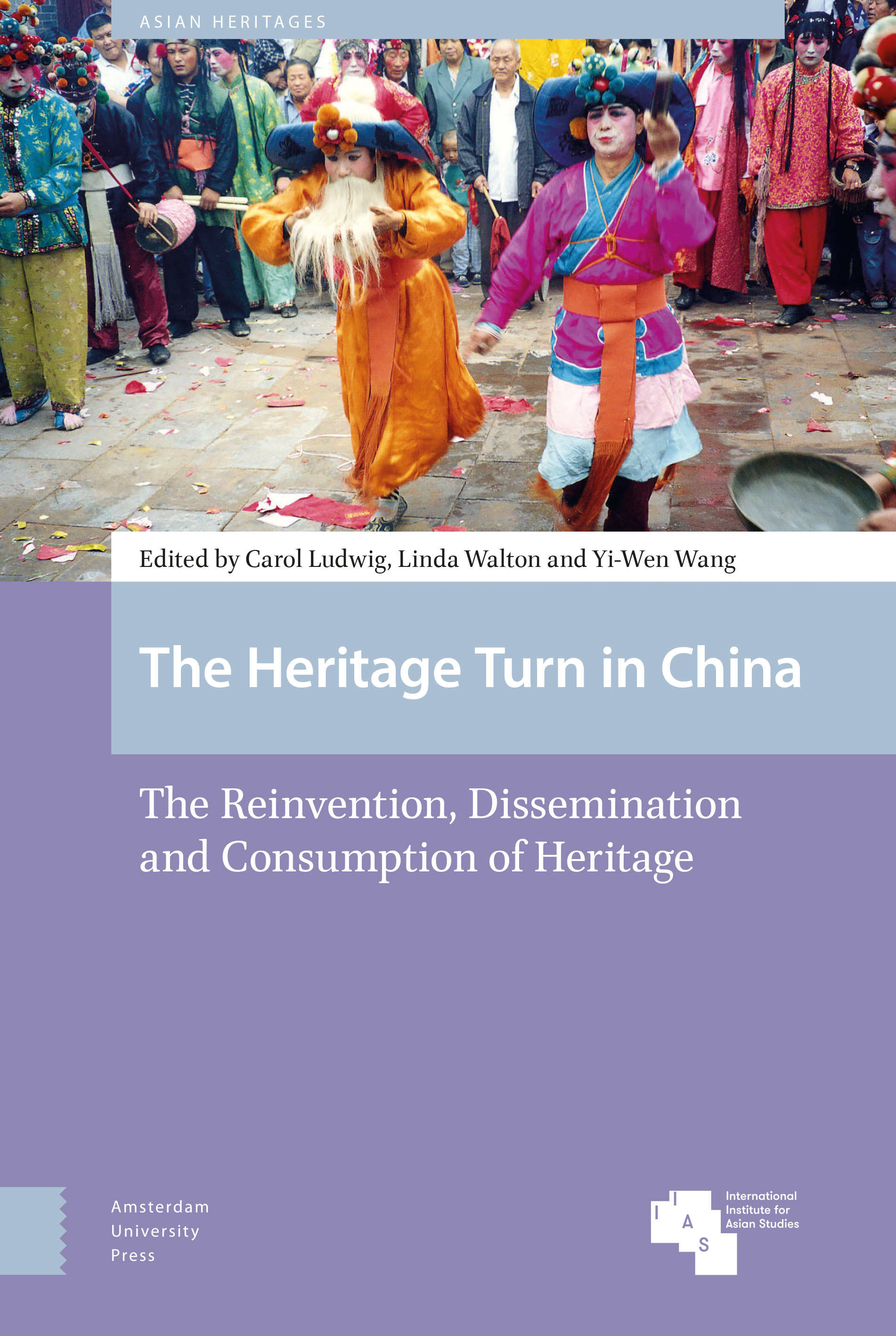
The Heritage Turn in China This edited volume focuses on heritage discourse and practice in China today as it has evolved from the 'heritage turn' that can be dated to the 1990s. Using a variety of disciplinary approaches to regionally and topically diverse case studies, the contributors to this volume show how particular versions of the past are selected, (re)invented, disseminated and consumed for contemporary purposes. These studies explore how the Chinese state utilises heritage not only for tourism, entertainment, educational and commercial purposes, but also as part of broader political strategies on both the national and international stage. Together, they argue that the Chinese state employs modes of heritage governance to construct new modernities while strengthening collective national identity in support of both its political legitimacy and its claim to status as an international superpower. The authors also consider ways in which state management of heritage is contested by some stakeholders whose embrace of heritage has a different purpose and meaning. POLITICAL SCIENCE,Public Policy,Cultural Policy

Music Cities This book provides a critical academic evaluation of the ‘music city’ as a form of urban cultural policy that has been keenly adopted in policy circles across the globe, but which as yet has only been subject to limited empirical and conceptual interrogation. With a particular focus on heritage, planning, tourism and regulatory measures, this book explores how local geographical, social and economic contexts and particularities shape the nature of music city policies (or lack thereof) in particular cities. The book broadens academic interrogation of music cities to include cities as diverse as San Francisco, Liverpool, Chennai, Havana, San Juan, Birmingham and Southampton. Contributors include both academic and professional practitioners and, consequently, this book represents one of the most diverse attempts yet to critically engage with music cities as a global cultural policy concept. POLITICAL SCIENCE,Public Policy,Cultural Policy
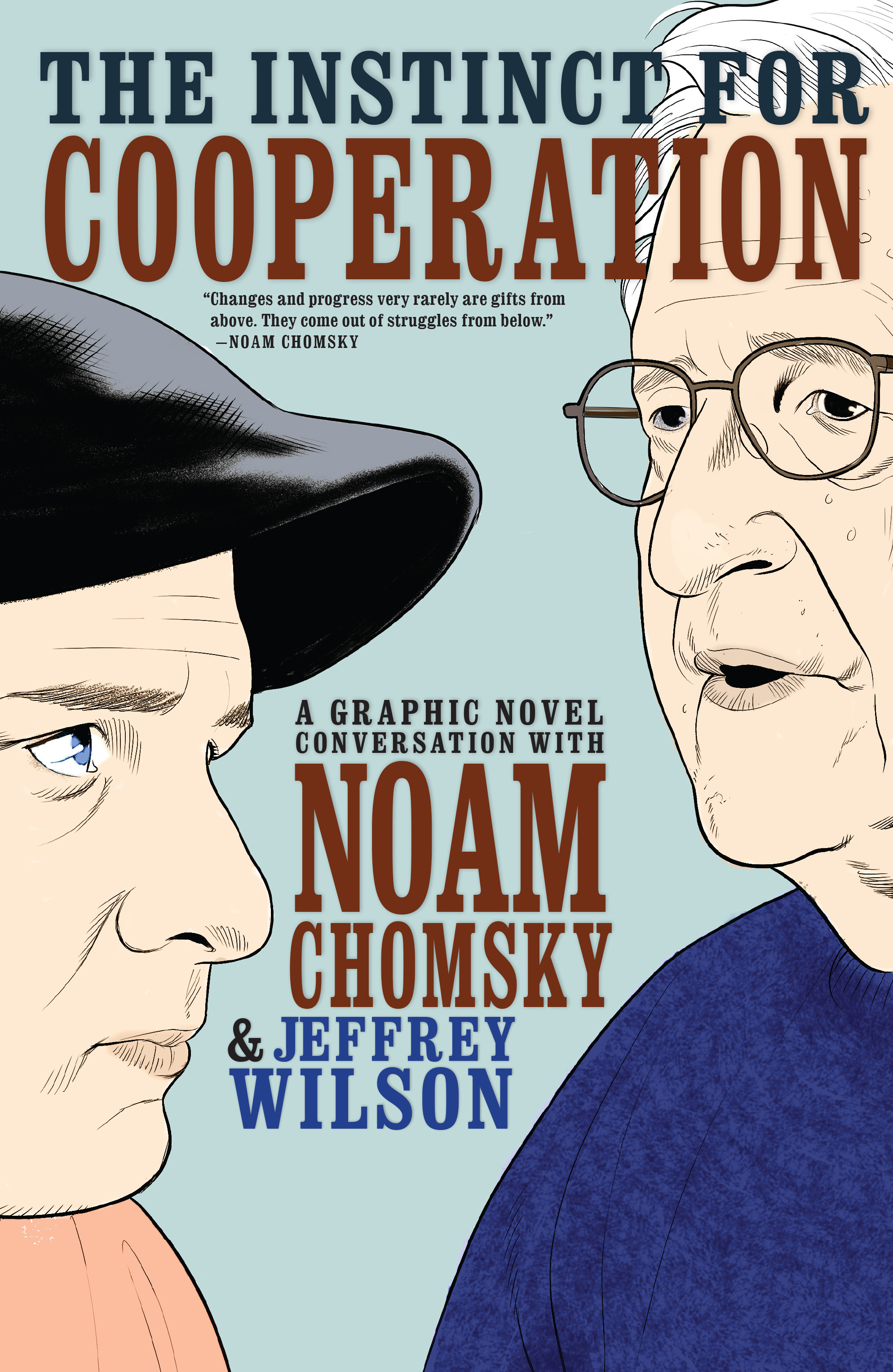
The Instinct for Cooperation In the tradition of Joe Sacco's graphic journalism comes the first interview-based graphic novel treatment of Noam Chomsky's political ideas and activism. An astonishing graphic novel that brings Chomsky's political analysis to bear on real people's stories on the frontlines of America's struggle for economic justice and human dignity. The Instinct for Cooperation innovatively balances those real-life stories of struggle with conversations the author has had with Chomsky on how best to understand them. Although the themes are wide-ranging, this book is ultimately about the importance and need for spaces of resistance in countering state and other institutional forms of violence. For example, when discussing the removal of books by police and sanitation workers from Zuccotti Park in November of 2011, Chomsky paused to say "Arizona knows all about that," referring to the 2010 ban of Mexican American Studies in Tucson schools under Arizona House Bill 2281, which deemed classes that taught "ethnic solidarity" to be illegal. Rather than footnote the reference, Wilson tells that story. Like Joe Sacco's animated political journalism, this book offers a unique perspective on current issues, while providing a major contribution to the understanding of Chomsky's political theories. POLITICAL SCIENCE,Public Policy,Cultural Policy

Blaming Islam Why fears about Muslim integration into Western society—propagated opportunistically by some on the right—misread history and misunderstand multiculturalism. In the United States and in Europe, politicians, activists, and even some scholars argue that Islam is incompatible with Western values and that we put ourselves at risk if we believe that Muslim immigrants can integrate into our society. Norway's Anders Behring Breivik took this argument to its extreme and murderous conclusion in July 2011. Meanwhile in the United States, state legislatures' efforts to ban the practice of Islamic law, or sharia, are gathering steam—despite a notable lack of evidence that sharia poses any real threat. In Blaming Islam, John Bowen uncovers the myths about Islam and Muslim integration into Western society, with a focus on the histories, policy, and rhetoric associated with Muslim immigration in Europe, the British experiment with sharia law for Muslim domestic disputes, and the claims of European and American writers that Islam threatens the West. Most important, he shows how exaggerated fears about Muslims misread history, misunderstand multiculturalism's aims, and reveal the opportunism of right wing parties who draw populist support by blaming Islam. POLITICAL SCIENCE,Public Policy,Cultural Policy
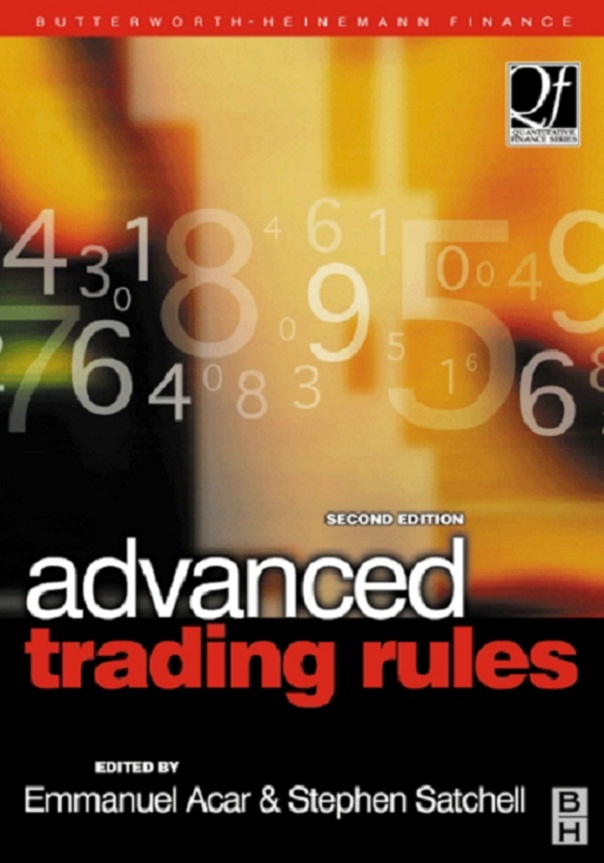
Advanced Trading Rules Advanced Trading Rules is the essential guide to state of the art techniques currently used by the very best financial traders, analysts and fund managers. The editors have brought together the world's leading professional and academic experts to explain how to understand, develop and apply cutting edge trading rules and systems. It is indispensable reading if you are involved in the derivatives, fixed income, foreign exchange and equities markets. Advanced Trading Rules demonstrates how to apply econometrics, computer modelling, technical and quantitative analysis to generate superior returns, showing how you can stay ahead of the curve by finding out why certain methods succeed or fail. Profit from this book by understanding how to use: stochastic properties of trading strategies; technical indicators; neural networks; genetic algorithms; quantitative techniques; charts. Financial markets professionals will discover a wealth of applicable ideas and methods to help them to improve their performance and profits. Students and academics working in this area will also benefit from the rigorous and theoretically sound analysis of this dynamic and exciting area of finance. The essential guide to state of the art techniques currently used by the very best financial traders, analysts and fund managers Provides a complete overview of cutting edge financial markets trading rules, including new material on technical analysis and evaluation Demonstrates how to apply econometrics, computer modeling, technical and quantitative analysis to generate superior returns POLITICAL SCIENCE,Public Policy,Economic Policy
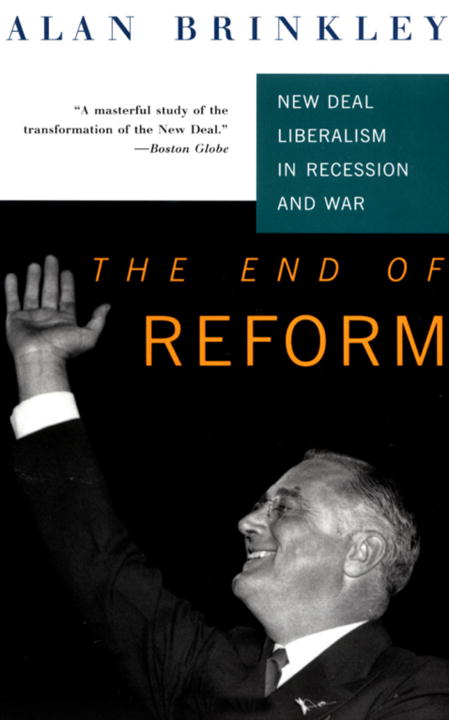
The End Of Reform At a time when liberalism is in disarray, this vastly illuminating book locates the origins of its crisis. Those origins, says Alan Brinkley, are paradoxically situated during the second term of Franklin Delano Roosevelt, whose New Deal had made liberalism a fixture of American politics and society. The End of Reform shows how the liberalism of the early New Deal—which set out to repair and, if necessary, restructure America’s economy—gave way to its contemporary counterpart, which is less hostile to corporate capitalism and more solicitous of individual rights. Clearly and dramatically, Brinkley identifies the personalities and events responsible for this transformation while pointing to the broader trends in American society that made the politics of reform increasingly popular. It is both a major reinterpretation of the New Deal and a crucial map of the road to today’s political landscape. POLITICAL SCIENCE,Public Policy,Economic Policy
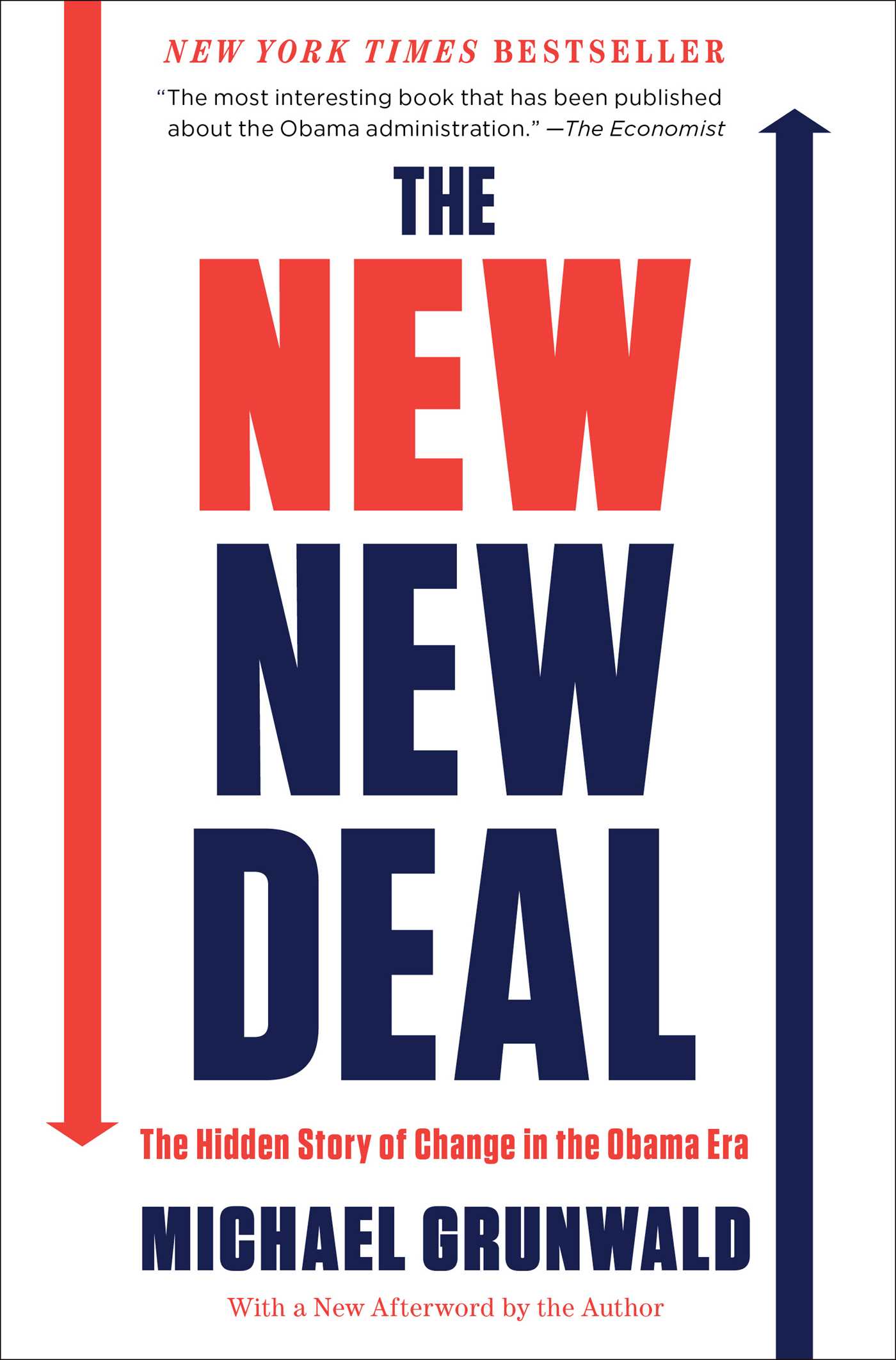
The New New Deal In a riveting account based on new documents and interviews with more than 400 sources on both sides of the aisle, award-winning reporter Michael Grunwald reveals the vivid story behind President Obama’s $800 billion stimulus bill, one of the most important and least understood pieces of legislation in the history of the country. Grunwald’s meticulous reporting shows how the stimulus, though reviled on the right and the left, helped prevent a depression while jump-starting the president’s agenda for lasting change. As ambitious and far-reaching as FDR’s New Deal, the Recovery Act is a down payment on the nation’s economic and environmental future, the purest distillation of change in the Obama era. The stimulus has launched a transition to a clean-energy economy, doubled our renewable power, and financed unprecedented investments in energy efficiency, a smarter grid, electric cars, advanced biofuels, and green manufacturing. It is computerizing America’s pen-and-paper medical system. Its Race to the Top is the boldest education reform in U.S. history. It has put in place the biggest middle-class tax cuts in a generation, the largest research investments ever, and the most extensive infrastructure investments since Eisenhower’s interstate highway system. It includes the largest expansion of antipoverty programs since the Great Society, lifting millions of Americans above the poverty line, reducing homelessness, and modernizing unemployment insurance. Like the first New Deal, Obama’s stimulus has created legacies that last: the world’s largest wind and solar projects, a new battery industry, a fledgling high-speed rail network, and the world’s highest-speed Internet network. Michael Grunwald goes behind the scenes—sitting in on cabinet meetings, as well as recounting the secret strategy sessions where Republicans devised their resistance to Obama—to show how the stimulus was born, how it fueled a resurgence on the right, and how it is changing America. The New New Deal shatters the conventional Washington narrative and it will redefine the way Obama’s first term is perceived. POLITICAL SCIENCE,Public Policy,Economic Policy

Spreading the Wealth When Barack Obama told “Joe the Plumber” that he wanted to “spread the wealth around,” he wasn’t just using a figure of speech. Since the 2008 campaign, Stanley Kurtz has established himself as one of Barack Obama’s most effective and well-informed critics. He was the first to expose the extent of Obama’s ties to radicals such as Bill Ayers and ACORN. Now Kurtz reveals new evidence that the administration’s talk about helping the middle class is essentially a smoke screen. Behind the scenes, plans are under way for a serious push toward wealth redistribution, with the suburban middle class—not the so-called one percent—bearing the brunt of it. Why haven’t we heard more about policies that will lead to redistribution? In part, of course, because controversies over Obamacare, unemployment, and the exploding budget deficit have taken the media spotlight. But the main reason, according to Kurtz, is that Obama doesn’t want to tip his hand about his second term. He knows that his plans will alienate the moderate swing voters who hold the key to his reelection. Drawing on previously overlooked sources, Kurtz cuts through that smoke screen to reveal what’s really going on. Radicals from outside the administration—including key Obama allies from his early community organizing days—have been quietly influencing policy, in areas ranging from education to stimulus spending. Their goal: to increase the influence of America’s cities over their suburban neighbors so that eventually suburban independence will vanish. In the eyes of Obama’s former mentors—followers of leftist radical Saul Alinsky—suburbs are breeding grounds for bigotry and greed. The classic American dream of a suburban house and high quality, locally controlled schools strikes them as selfishness, a waste of resources that should be redirected to the urban poor. The regulatory groundwork laid so far is just a prelude to what’s to come: substantial redistribution of tax dollars. Over time, cities would effectively swallow up their surrounding municipalities, with merged school districts and forced redistribution of public spending killing the appeal of the suburbs. The result would be a profound transformation of American society. Kurtz shows the unbroken line of continuity from Obama’s community organizing roots to his presidency. And he reveals why his plan to undermine the suburbs means so much to him personally. Kurtz’s revelations are sure to be hotly disputed. But they are essential to helping voters make an informed choice about whether to reward the president with a second term. POLITICAL SCIENCE,Public Policy,Economic Policy
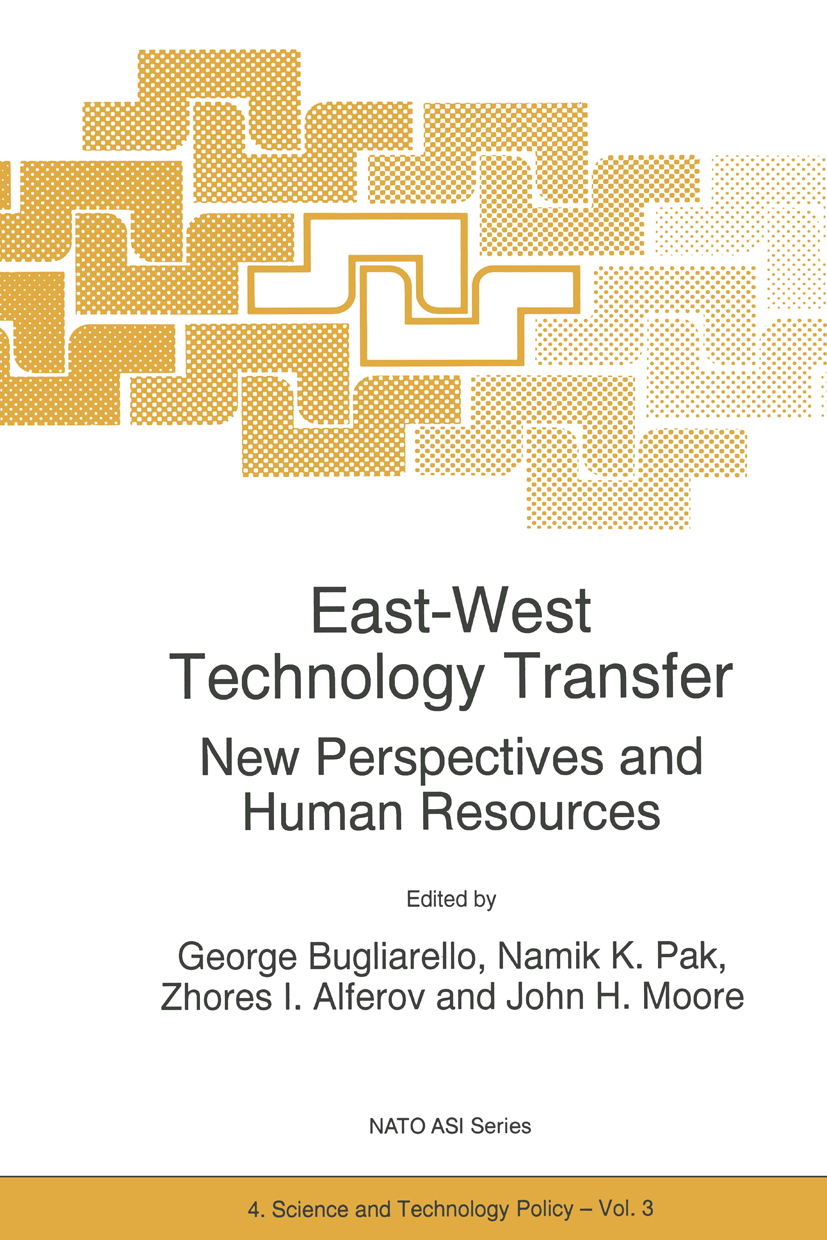
East-West Technology Transfer Proceedings of the NATO Advanced Research Workshop on `Human Resources and Leadership for Technology Transfer between NATO Countries and Cooperation Partner Countries', Ankara, Turkey, July 18-21, 1994 POLITICAL SCIENCE,Public Policy,Economic Policy
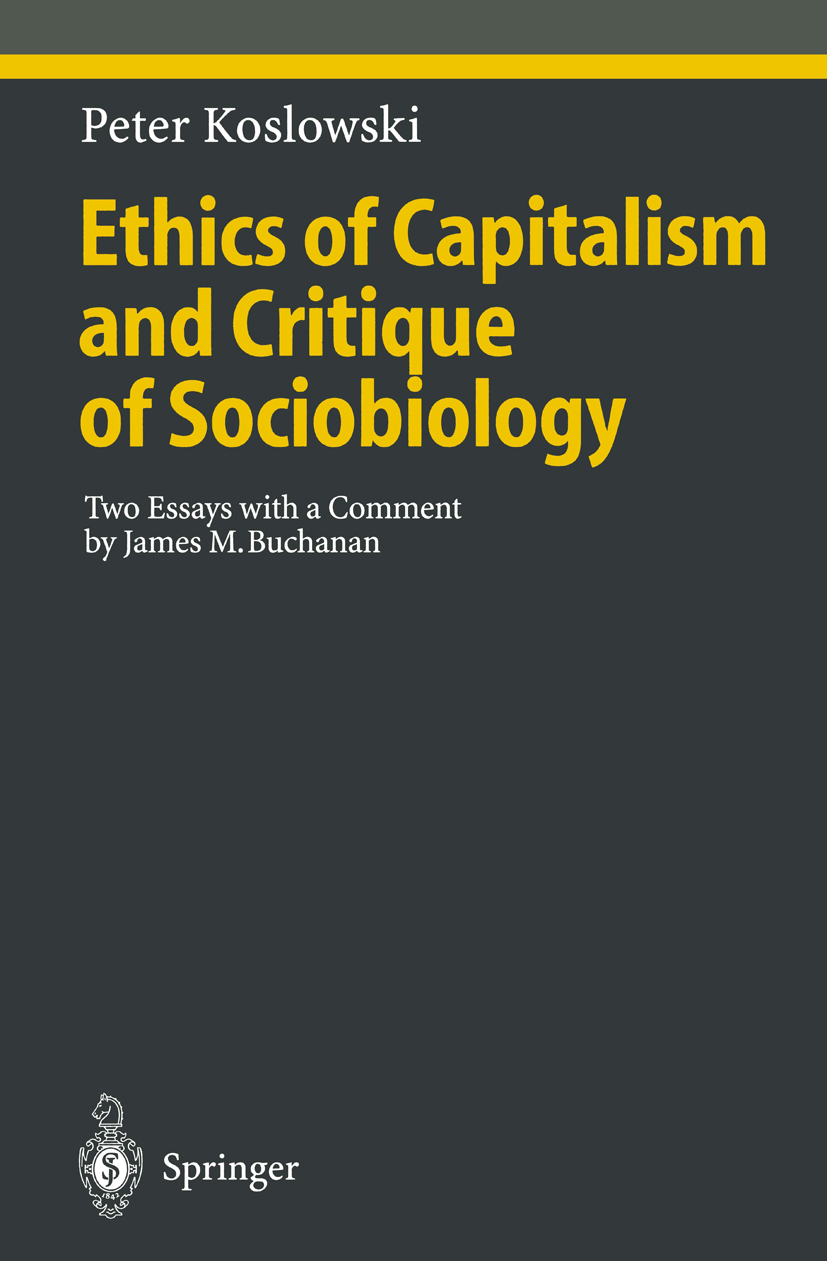
Ethics of Capitalism and Critique of Sociobiology This book publishes the English translation of texts that appeared first in Gennan in two separate booklets. Part One, The Ethics of Capitalism includ ing the comment by JAMES M. BUCHANAN, has been published in Gennan under the title Ethik des Kapitalismus, Ttibingen (J.C.B. Mohr [paul Sie beck)) 1982, 5th edition 1995, in the series "Walter Eucken Institut, Vort:rt1ge und Aufsatze", vol. 87. Part Two, Evolution and Society. A Critique of So ciobiology, appeared first in German under the title Evolution und Gesell schaft. Eine Auseinandersetzung mit der Soziobiologie, Ttibingen (J.e.B. Mohr [Paul Siebeck)) 1984, 2nd edition 1989, in the same series, vol. 98. Part One of the book has been translated by the author, Part Two by DAVID AMBUEL. I should like to thank Liberty Fund Inc., Indianapolis, USA, for its sup port of the translation of Part Two, Georg Siebeck of J.C.B. Mohr (paul Siebeck) Publishers, Ttibingen, for the pennission to publish the English translation of the two essays and to my co-workers at the Forschungsinstitut ftir Philosophie Hannover -The Hannover Institute of Philosophical Re search, Hannover, Germany, for their support in editing this volume. POLITICAL SCIENCE,Public Policy,Economic Policy

Getting Off Track In this concise volume, leading economist John B. Taylor offers empirical research to explain what caused the current financial crisis, what prolonged it, and what dramatically worsened it more than a year after it began. The evidence he presents strongly suggests that specific government actions and interventions are largely to blame and that any future government interventions must be based on a clearly stated diagnosis of the problem and a rationale for the interventions. POLITICAL SCIENCE,Public Policy,Economic Policy
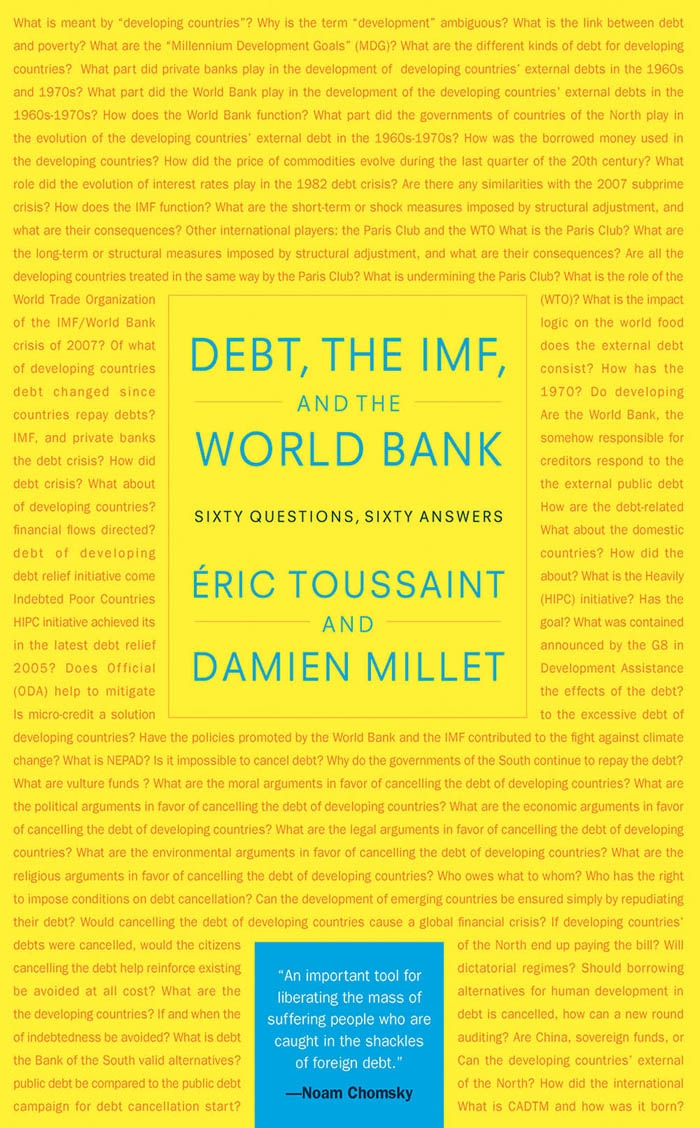
Debt, the IMF, and the World Bank Mainstream economists tell us that developing countries will replicate the economic achievements of the rich countries if they implement the correct “free-marketâ€policies. But scholars and activists Toussaint and Millet demonstrate that this is patently false. Drawing on a wealth of detailed evidence, they explain how developed economies have systematically and deliberately exploited the less-developed economies by forcing them into unequal trade and political relationships. Integral to this arrangement are the international economic institutions ostensibly created to safeguard the stability of the global economy—the International Monetary Fund (IMF) and the World Bank—and the imposition of massive foreign debt on poor countries. The authors explain in simple language, and ample use of graphics, the multiple contours of this exploitative system, its history, and how it continues to function in the present day.Ultimately, Toussaint and Millet advocate cancellation of all foreign debt for developing countries and provide arguments from a number of perspectives—legal, economic, moral. Presented in an accessible and easily-referenced question and answer format, Debt, the IMF, and the World Bank is an essential tool for the global justice movement. POLITICAL SCIENCE,Public Policy,Economic Policy

Requiem for the American Dream A NEW YORK TIMES BESTSELLER! In his first major book on the subject of income inequality, Noam Chomsky skewers the fundamental tenets of neoliberalism and casts a clear, cold, patient eye on the economic facts of life. What are the ten principles of concentration of wealth and power at work in America today? They're simple enough: reduce democracy, shape ideology, redesign the economy, shift the burden onto the poor and middle classes, attack the solidarity of the people, let special interests run the regulators, engineer election results, use fear and the power of the state to keep the rabble in line, manufacture consent, marginalize the population. In Requiem for the American Dream, Chomsky devotes a chapter to each of these ten principles, and adds readings from some of the core texts that have influenced his thinking to bolster his argument. To create Requiem for the American Dream, Chomsky and his editors, the filmmakers Peter Hutchison, Kelly Nyks, and Jared P. Scott, spent countless hours together over the course of five years, from 2011 to 2016. After the release of the film version, Chomsky and the editors returned to the many hours of tape and transcript and created a document that included three times as much text as was used in the film. The book that has resulted is nonetheless arguably the most succinct and tightly woven of Chomsky's long career, a beautiful vessel--including old-fashioned ligatures in the typeface--in which to carry Chomsky's bold and uncompromising vision, his perspective on the economic reality and its impact on our political and moral well-being as a nation. "During the Great Depression, which I'm old enough to remember, it was bad–much worse subjectively than today. But there was a sense that we'll get out of this somehow, an expectation that things were going to get better . . ." —from Requiem for the American Dream POLITICAL SCIENCE,Public Policy,Economic Policy

Economic and Philosophic Manuscripts of 1844 In the Economic and Philosophic Manuscripts of 1844 Marx explains how, under capitalism, people rely on labor to live. In the past people could rely on Nature itself for their natural needs; in modern society, if one wants to eat, one must work: it is only through money that one may survive. Thus, man becomes a slave to his wages. It is only through his work that he can find enough money to continue to live; but he doesn't simply live, he actually only survives, as a worker. Labor is only used to create more wealth, instead of achieving the fulfillment of human nature. Wilder Publications is a green publisher. All of our books are printed to order. This reduces waste and helps us keep prices low while greatly reducing our impact on the environment. POLITICAL SCIENCE,Public Policy,Economic Policy

The Chickenshit Club Winner of the 2018 Excellence in Financial Journalism Award From Pulitzer Prize–winning journalist Jesse Eisinger, “a fast moving, fly-on-the-wall, disheartening look at the deterioration of the Justice Department and the Securities and Exchange Commission…It is a book of superheroes†(San Francisco Review of Books). Why were no bankers put in prison after the financial crisis of 2008? Why do CEOs seem to commit wrongdoing with impunity? The problem goes beyond banks deemed “Too Big to Fail†to almost every large corporation in America—to pharmaceutical companies and auto manufacturers and beyond. The Chickenshit Club—an inside reference to prosecutors too scared of failure and too daunted by legal impediments to do their jobs—explains why in “an absorbing financial history, a monumental work of journalism…a first-rate study of the federal bureaucracy†(Bloomberg Businessweek). Jesse Eisinger begins the story in the 1970s, when the government pioneered the notion that top corporate executives, not just seedy crooks, could commit heinous crimes and go to prison. He brings us to trading desks on Wall Street, to corporate boardrooms and the offices of prosecutors and FBI agents. These revealing looks provide context for the evolution of the Justice Department’s approach to pursuing corporate criminals through the early 2000s and into the Justice Department of today, including the prosecutorial fiascos, corporate lobbying, trial losses, and culture shifts that have stripped the government of the will and ability to prosecute top corporate executives. “Brave and elegant…a fearless reporter…Eisinger’s important and profound book takes no prisoners†(The Washington Post). Exposing one of the most important scandals of our time, The Chickenshit Club provides a clear, detailed explanation as to how our Justice Department has come to avoid, bungle, and mismanage the fight to bring these alleged criminals to justice. “This book is a wakeup call…a chilling read, and a needed one†(NPR.org). POLITICAL SCIENCE,Public Policy,Economic Policy

The War on Normal People The New York Times bestseller from CNN Political Commentator and 2020 former Democratic presidential candidate Andrew Yang, this thought-provoking and prescient call-to-action outlines the urgent steps America must take, including Universal Basic Income (UBI), to stabilize our economy amid rapid technological change and automation. The shift toward automation is about to create a tsunami of unemployment. Not in the distant future--now. One recent estimate predicts 45 million American workers will lose their jobs within the next twelve years--jobs that won't be replaced. In a future marked by restlessness and chronic unemployment, what will happen to American society? In The War on Normal People, Andrew Yang paints a dire portrait of the American economy. Rapidly advancing technologies like artificial intelligence, robotics and automation software are making millions of Americans' livelihoods irrelevant. The consequences of these trends are already being felt across our communities in the form of political unrest, drug use, and other social ills. The future looks dire-but is it unavoidable? In The War on Normal People, Yang imagines a different future--one in which having a job is distinct from the capacity to prosper and seek fulfillment. At this vision's core is Universal Basic Income, the concept of providing all citizens with a guaranteed income-and one that is rapidly gaining popularity among forward-thinking politicians and economists. Yang proposes that UBI is an essential step toward a new, more durable kind of economy, one he calls "human capitalism." POLITICAL SCIENCE,Public Policy,Economic Policy
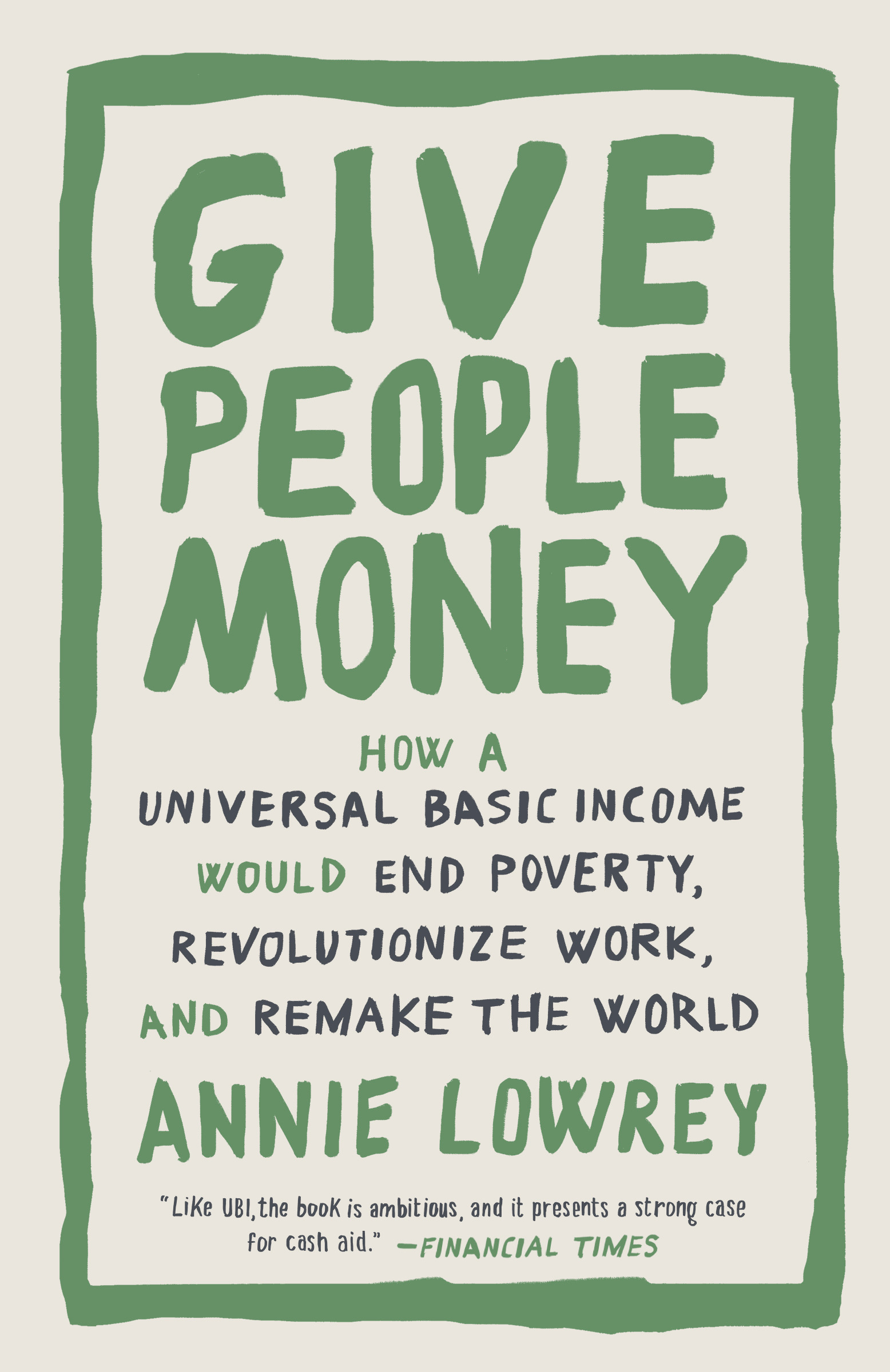
Give People Money A brilliantly reported, global look at universal basic income—a stipend given to every citizen—and why it might be the answer for our age of rising inequality, persistent poverty, and dazzling technology. Imagine if every month the government deposited $1,000 into your checking account, with no strings attached and nothing expected in return. It sounds crazy. But it has become one of the most influential and discussed policy ideas of our time. The founder of Facebook, President Obama’s chief economist, Canada and Finland’s governments, the conservative and labor movements’ leading intellectual lights—all are seriously debating versions of a UBI. In this sparkling and provocative book, economics writer Annie Lowrey looks at the global UBI movement. She travels to Kenya to see how a UBI is lifting the poorest people on earth out of destitution, India to see how inefficient government programs are failing the poor, South Korea to interrogate UBI’s intellectual pedigree, and Silicon Valley to meet the tech titans financing UBI pilots in expectation of a world with advanced artificial intelligence and little need for human labor. Lowrey also examines the challenges the movement faces: contradictory aims, uncomfortable costs, and most powerfully, the entrenched belief that no one should get something for nothing. The UBI movement calls into question our deepest intuitions about what we owe each other. Yet as Lowrey persuasively shows, a UBI—giving people money—is not just a solution to our problems, but a better foundation for our society in this age of marvels. POLITICAL SCIENCE,Public Policy,Economic Policy

The Future of Capitalism Bill Gates's Five Books for Summer Reading 2019 From world-renowned economist Paul Collier, a candid diagnosis of the failures of capitalism and a pragmatic and realistic vision for how we can repair it. Deep new rifts are tearing apart the fabric of the United States and other Western societies: thriving cities versus rural counties, the highly skilled elite versus the less educated, wealthy versus developing countries. As these divides deepen, we have lost the sense of ethical obligation to others that was crucial to the rise of post-war social democracy. So far these rifts have been answered only by the revivalist ideologies of populism and socialism, leading to the seismic upheavals of Trump, Brexit, and the return of the far-right in Germany. We have heard many critiques of capitalism but no one has laid out a realistic way to fix it, until now. In a passionate and polemical book, celebrated economist Paul Collier outlines brilliantly original and ethical ways of healing these rifts—economic, social and cultural—with the cool head of pragmatism, rather than the fervor of ideological revivalism. He reveals how he has personally lived across these three divides, moving from working-class Sheffield to hyper-competitive Oxford, and working between Britain and Africa, and acknowledges some of the failings of his profession. Drawing on his own solutions as well as ideas from some of the world’s most distinguished social scientists, he shows us how to save capitalism from itself—and free ourselves from the intellectual baggage of the twentieth century. POLITICAL SCIENCE,Public Policy,Economic Policy

Pipe Dreams Winner of the 2018 Writers’ Federation of New Brunswick Book Award for Non-Fiction Shortlisted for the 2018 Writers' Trust Shaughnessy Cohen Prize for Political Writing Shortlisted for the 2019 JW Dafoe Book Prize A timely chronicle of how Canada's oil pipelines have become hotbeds for debate about our energy future, Indigenous rights, environmental activism, and east-west political tensions. Pipe Dreams is the dramatic story of the rise and fall of the Energy East pipeline and the broader battle over climate and energy in Canada. The project was to be a monumental undertaking, beginning near Edmonton, AB, and stretching over four thousand kilometres, through Montreal to the Irving Oil refinery in Saint John, NB. Conceived as a back-up plan for the stalled Keystone XL pipeline, it became the crucible for a national debate over the future of oil. In a cross-country journey, Poitras talked to industry executives, prairie ranchers, First Nations chiefs, mayors, premiers, cabinet ministers, and refinery workers. He also explored Canada's perplexing oil relationship with the United States: our industry is literally tied to its American counterpart with sinews of steel. The Energy East pipeline represented a new direction, designed to get Alberta oil sands crude to lucrative world markets. Yet it was promoted in explicitly nationalist terms: the country was said to be reorienting itself along its east-west axis, tying itself together, again, with a great feat of engineering. By the time the journey ended, the story had become a kind of whodunit: Poitras witnessed the slow-motion killing of the fifteen billion dollar project. Unfolding in tandem with clashes over the Trans Mountain pipeline, Energy East's demise heralded a potential turning point not just for a single proposal, but for Canada's carbon economy. Entertaining, informative, and insightful, Pipe Dreams offers a clear picture of the complicated political, environmental, and economic issues that Canadians face. POLITICAL SCIENCE,Public Policy,Economic Policy

Why Can't You Afford a Home? Throughout the Western world, a whole generation is being priced out of the housing market. For millions of people, particularly millennials, the basic goal of acquiring decent, affordable accommodation is a distant dream. Leading economist Josh Ryan-Collins argues that to understand this crisis, we must examine a crucial paradox at the heart of modern capitalism. The interaction of private home ownership and a lightly regulated commercial banking system leads to a feedback cycle. Unlimited credit and money flows into an inherently finite supply of property, which causes rising house prices, declining home ownership, rising inequality and debt, stagnant growth and financial instability. Radical reforms are needed to break the cycle. This engaging and topical book will be essential reading for anyone who wants to understand why they can’t find an affordable home, and what we can do about it. POLITICAL SCIENCE,Public Policy,Economic Policy

Renminbi Internationalization A Brookings Institution Press and Asian Development Bank Institute publication Meet the next global currency: the Chinese renminbi, or the "redback." Following the global financial crisis of 2008, China's major monetary policy objective is the internationalization of the renminbi, that is, to create an inter-national role for its currency akin to the international role currently played by the U.S. dollar. Renminbi internationalization is a hot topic, for good reason. It is, essentially, a window onto the Chinese government's aspirations and the larger process of economic and financial transformation. Making the renminbi a global currency requires rebalancing the Chinese economy, developing the country's financial markets and opening them to the rest of the world, and moving to a more flexible exchange rate. In other words, the internationalization of the renminbi is a monetary and financial issue with much broader supra-monetary and financial implications. This book offers a new perspective on the larger issues of economic, financial, and institutional change in what will eventually be the world's largest economy. POLITICAL SCIENCE,Public Policy,Economic Policy
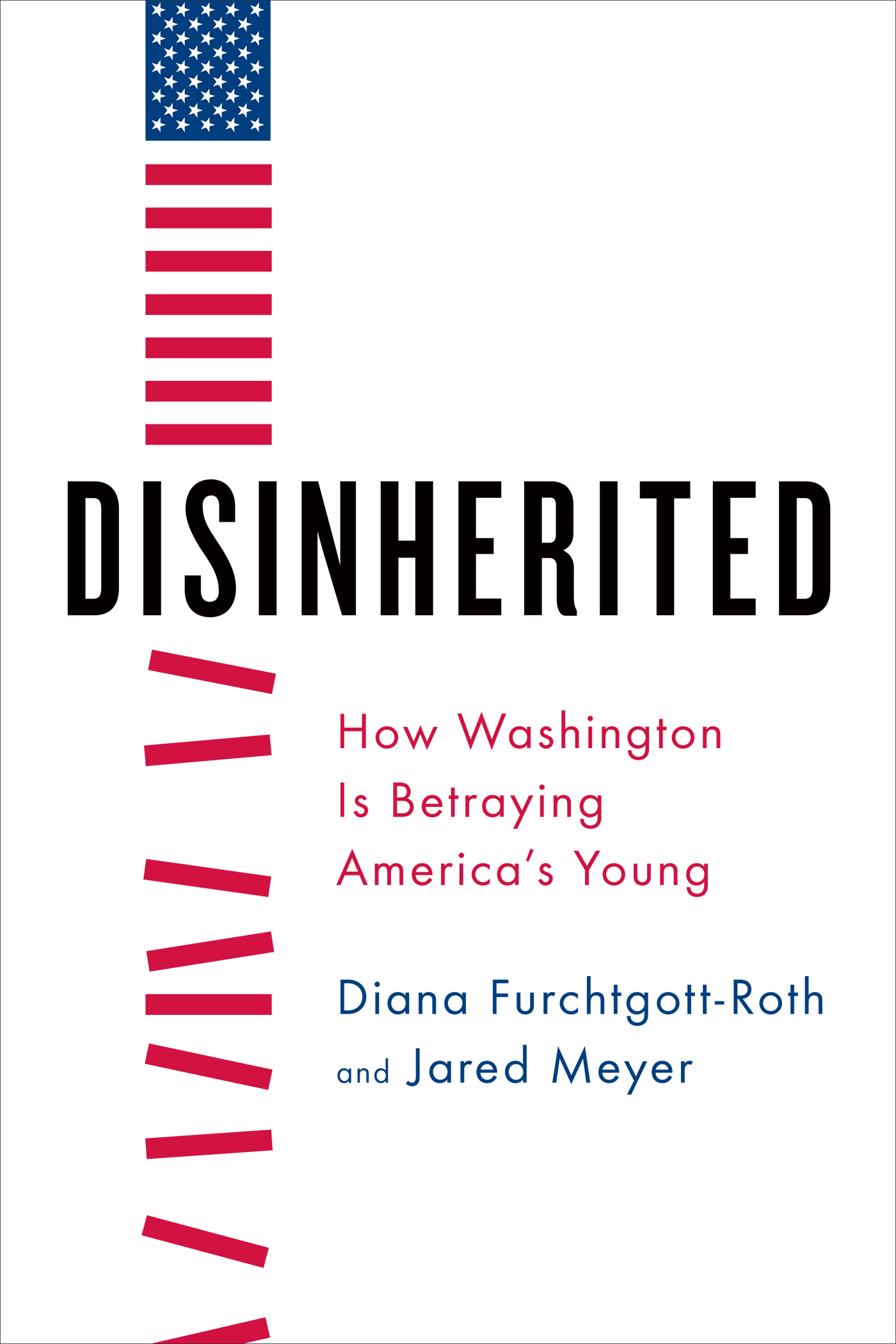
Disinherited Tens of millions of Americans are between the ages of 18 and 30. These Americans, known as millennials, are, or soon will be, entering the workforce. For them, achieving success will be more difficult than it was for young people in the past. This is not because they are less intelligent, they have worked less hard, or they are any less deserving of the American dream. It is because Washington made decisions that render their lives more difficult than those of their parents or grandparents. Their younger siblings and their children will be even worse off, allbecause Washington has refused to fix the problem. This book describes the personal stories of several members of this disinherited generation. Their experiences are not unique. It is impossible to hear these stories and not understand that holding back a nation’s young is the antithesis of fairness and no way to make economic or social progress. Their stories are an indictment of America’s treatment of its young. A nation that prides itself on its future has mortgaged it. A nation that historically took pride in its youth culture has become a nation that steals from its young. People who should have fulfilling, productive lives are sidelined, unemployed, or underemployed. Meanwhile, America expects millennials and others of the disinherited generation to pay higher taxes for government programs that benefit middle-aged and older Americans, many of whom have better jobs and more assets. It is time someone told the full story of the crisis facing America’s young. The future of America can be saved, but only if our government’s betrayal comes to an end. It is a war without victors, only victims. The birthright of the America’s young must be restored, and the time to do so is now. This book explains how. POLITICAL SCIENCE,Public Policy,Economic Policy

The Left Case Against the EU Many on the Left see the European Union as a fundamentally benign project with the potential to underpin ever greater cooperation and progress. If it has drifted rightward, the answer is to fight for reform from within. In this iconoclastic polemic, economist Costas Lapavitsas demolishes this view. He contends that the EU’s response to the Eurozone crisis represents the ultimate transformation of the union into a neoliberal citadel that institutionally embeds austerity, privatization, and wage cuts. Concurrently, the rise of German hegemony has divided the EU into an unstable core and dependent peripheries. These related developments make the EU impervious to meaningful reform. The solution is therefore a direct challenge to the EU project that stresses popular and national sovereignty as preconditions for true internationalist socialism. Lapavitsas’s powerful manifesto for a left opposition to the EU upends the wishful thinking that often characterizes the debate and will be a challenging read for all on the Left interested in the future of Europe. POLITICAL SCIENCE,Public Policy,Economic Policy

Transaction Man An Amazon Best History Book of 2019 "A splendid and beautifully written illustration of the tremendous importance public policy has for the daily lives of ordinary people." —Ryan Cooper, Washington Monthly Over the last generation, the United States has undergone seismic changes. Stable institutions have given way to frictionless transactions, which are celebrated no matter what collateral damage they generate. The concentration of great wealth has coincided with the fraying of social ties and the rise of inequality. How did all this come about? In Transaction Man, Nicholas Lemann explains the United States’—and the world’s—great transformation by examining three remarkable individuals who epitomized and helped create their eras. Adolf Berle, Franklin Delano Roosevelt’s chief theorist of the economy, imagined a society dominated by large corporations, which a newly powerful federal government had forced to become benign and stable institutions, contributing to the public good by offering stable employment and generous pensions. By the 1970s, the corporations’ large stockholders grew restive under this regime, and their chief theoretician, Harvard Business School’s Michael Jensen, insisted that firms should maximize shareholder value, whatever the consequences. Today, Silicon Valley titans such as the LinkedIn cofounder and venture capitalist Reid Hoffman hope “networks†can reknit our social fabric. Lemann interweaves these fresh and vivid profiles with a history of the Morgan Stanley investment bank from the 1930s through the financial crisis of 2008, while also tracking the rise and fall of a working-class Chicago neighborhood and the family-run car dealerships at its heart. Incisive and sweeping, Transaction Man is the definitive account of the reengineering of America and the enormous impact it has had on us all. POLITICAL SCIENCE,Public Policy,Economic Policy
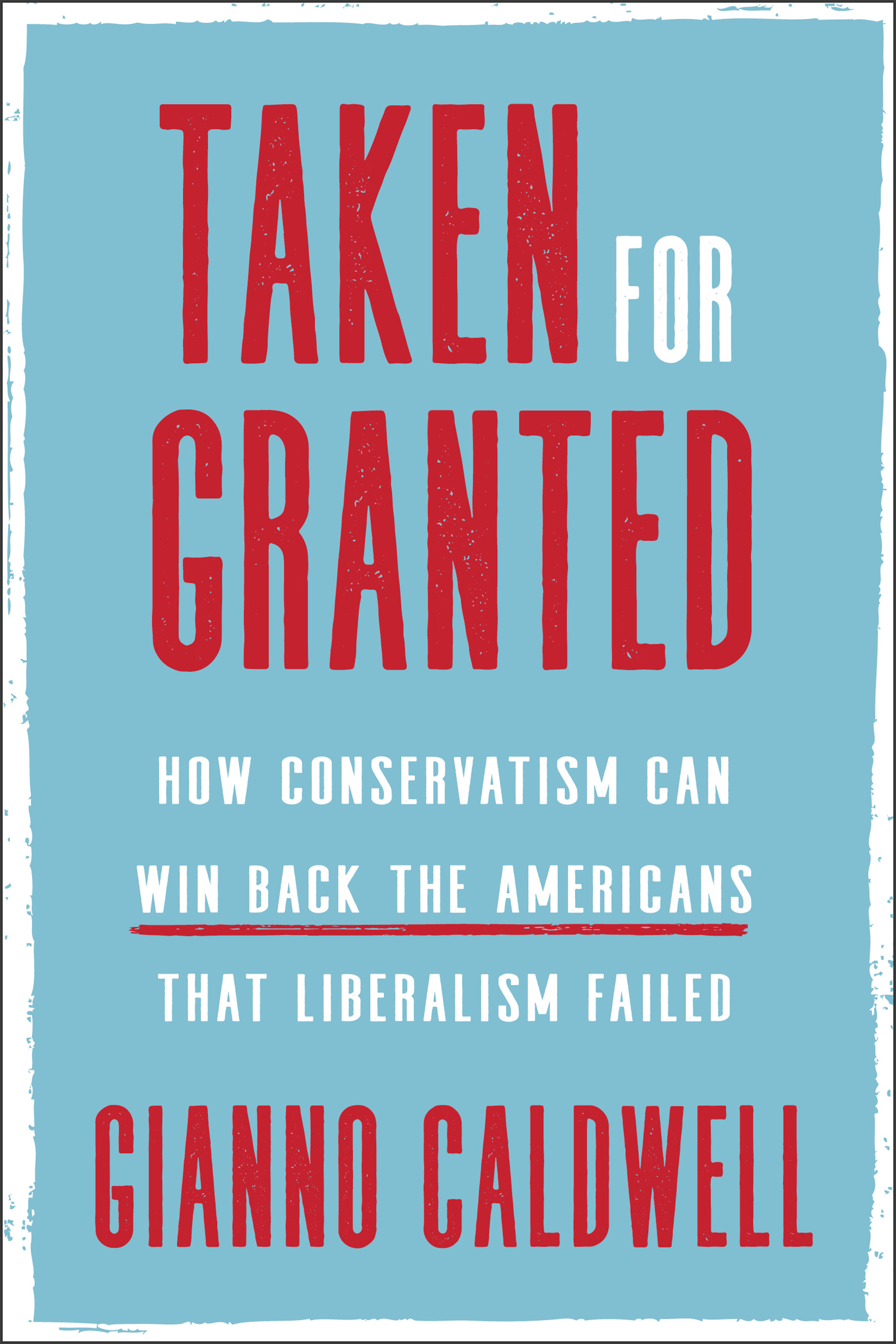
Taken for Granted A Fox News political analyst tackles some of our communities’ toughest challenges with timely insight from his own life: the story of how conservative values helped a kid from the South Side of Chicago find a life of opportunity. “A must-read.”—Brian Kilmeade, bestselling author of Sam Houston and the Alamo Avengers Born to a mother consumed by drugs and raised by his grandmother in poverty on the South Side of Chicago, Gianno Caldwell saw firsthand how lawmakers from both parties have failed African American voters on issues like poverty, welfare, and education. But as someone who beat the odds growing up under a fear-based mentality that limits what people can achieve, Caldwell believes there’s another way. In this groundbreaking book, the Fox News analyst describes his personal journey while detailing a hopeful vision for a nation no longer beholden to identity politics and self-limitations. Trapped within the expectations and traditions of our communities, families, political parties, faith, race, and gender, we fail to challenge our politicians and ourselves to create real change. Now more than ever, we need to confront preconceived notions about the Democrats and Republicans, public policy, and American history. Looking at the obstacles facing urban communities, such as crime, education, and social mobility, Caldwell digs beneath the statistics. By spotlighting the moments that enabled his rise to success, he proffers steps that can help more people overcome the odds—whether through policy reform or the heroic efforts of men and women who are already working to make a difference in their own communities. POLITICAL SCIENCE,Public Policy,Economic Policy
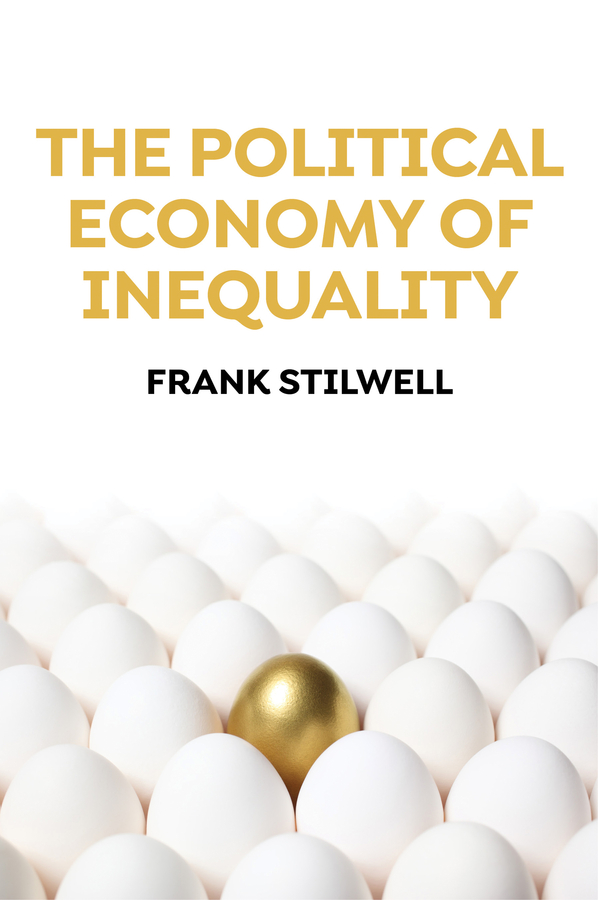
The Political Economy of Inequality During the last few decades, the gap between the incomes, wealth and living standards of rich and poor people has increased in most countries. Economic inequality has become a defining issue of our age. In this book, leading political economist Frank Stilwell provides a comprehensive overview of the nature, causes, and consequences of this growing divide. He shows how we can understand inequalities of wealth and incomes, globally and nationally, examines the scale of the problem and explains how it affects our wellbeing. He also shows that, although governments are often committed to ‘growth at all costs’ and ‘trickle down’ economics, there are alternative public policies that could be used to narrow the gap between rich and poor. Stilwell’s engaging and clear guide to the issues will be indispensable reading for all students, general readers and scholars interested in inequality in political economy, economics, public policy and beyond. POLITICAL SCIENCE,Public Policy,Economic Policy
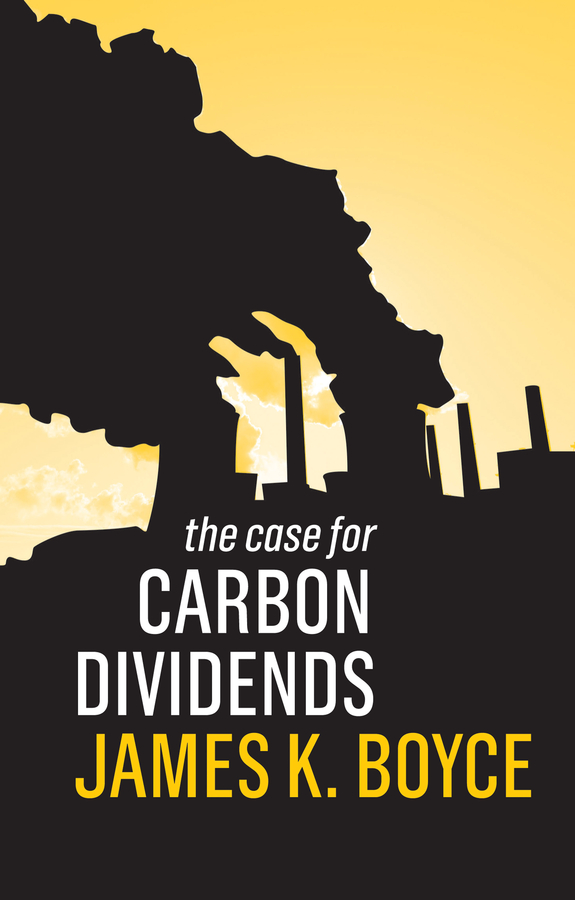
The Case for Carbon Dividends The supreme challenge of our time is tackling climate change. We urgently need to curtail our use of fossil fuels – but how can we do so in a just and feasible way? In this compelling book, leading economist James Boyce shows that the key to solving this conundrum is to put a limit on carbon emissions, thereby raising the price of fossil fuels and generating strong incentives for clean energy. But there is a formidable hurdle: how do we secure broad public support for a policy that increases fuel costs for consumers? Boyce powerfully argues that carbon pricing can be made just and politically durable only if linked to returning the revenue to the public as carbon dividends. Founded on the principle that the gifts of nature belong to us all, not to corporations or governments, this bold reform could spark a twenty-first-century clean energy revolution. Essential reading for all concerned citizens, policy-makers, and students of public policy and environmental economics, this book will be a transformative contribution to one of the most important policy debates of our era. POLITICAL SCIENCE,Public Policy,Economic Policy
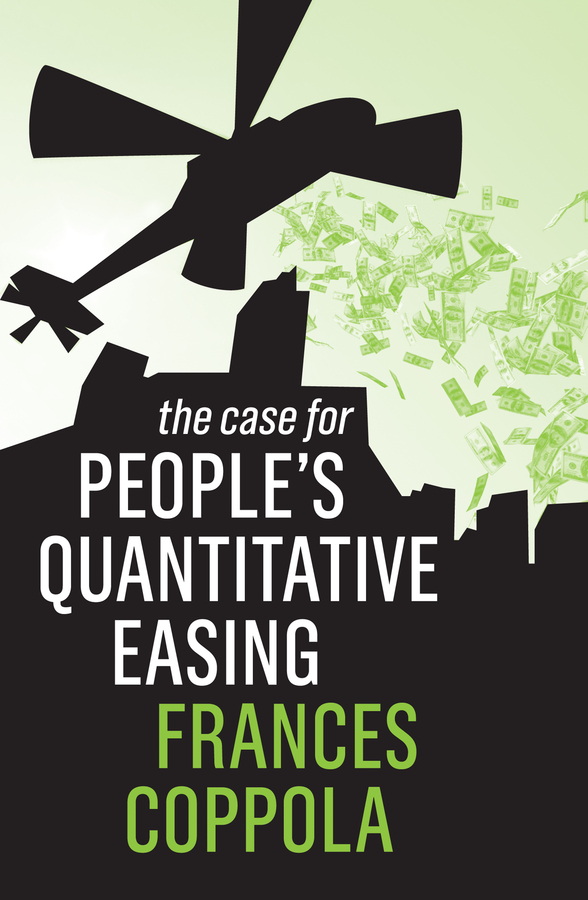
The Case For People's Quantitative Easing In the wake of the 2008 financial crisis, central banks created trillions of dollars of new money, and poured it into financial markets. ‘Quantitative Easing’ (QE) was supposed to prevent deflation and restore economic growth. But the money didn’t go to ordinary people: it went to the rich, who didn’t need it. It went to big corporations and banks – the same banks whose reckless lending caused the crash. This led to a decade of stagnation, not recovery. QE failed. In this book, Frances Coppola makes the case for a ‘people’s QE’, in which the money goes directly to ordinary people and small businesses. She argues that it is the fairest and most effective way of restoring crisis-hit economies and helping to solve the long-term challenges of ageing populations, automation and climate change. POLITICAL SCIENCE,Public Policy,Economic Policy
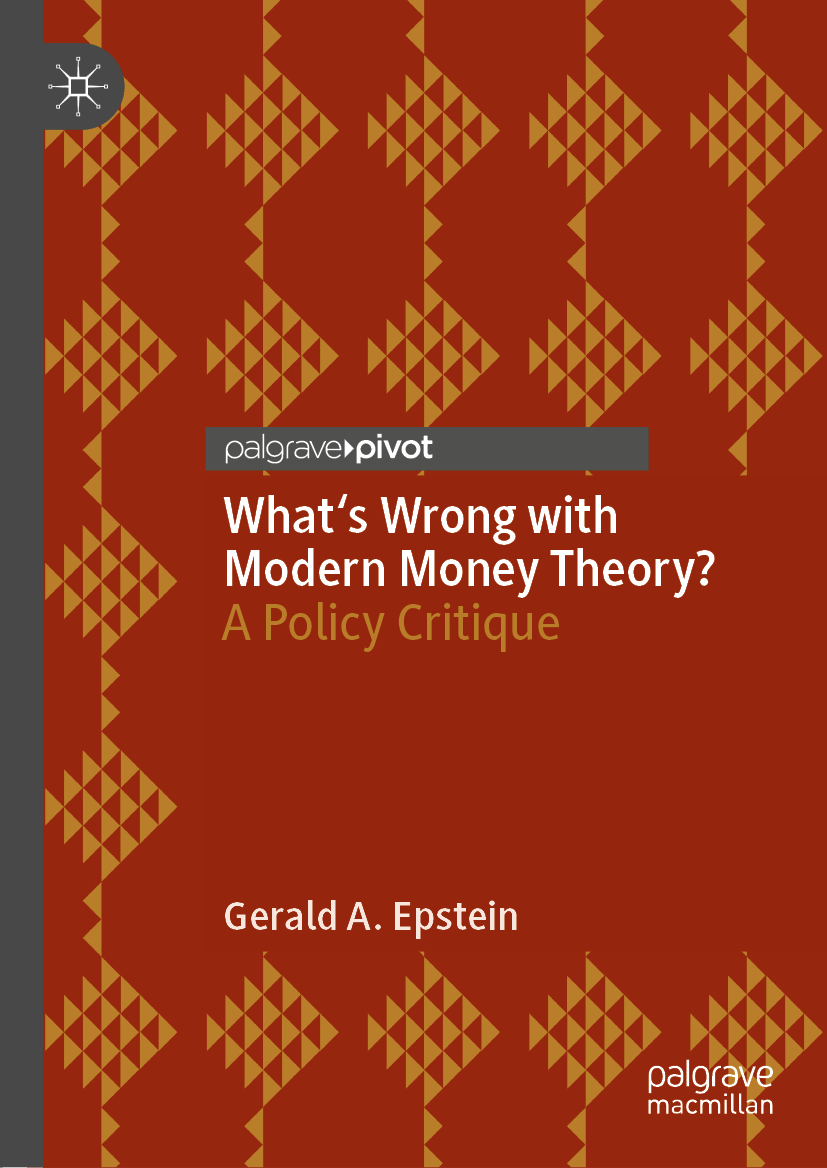
What's Wrong with Modern Money Theory? This Palgrave Pivot assesses the validity of Modern Money Theory’s approach to macroeconomic policy, specifically monetary and fiscal policy. Whereas other papers have focused primarily on theoretical and doctrinal issues, this book focuses primarily on an analysis of MMT’s policy approach. Though drawing on academic literature, this book’s approach is empirical and policy-based, making it accessible to scholars and the public alike. It addresses a burning question in the policy and politics of the US and elsewhere where MMT is gaining a policy foothold, especially among progressive activists and politicians: Is MMT, in fact, a good guide for progressive macroeconomic policy? The main focus of this book is to explain why the answer to this question is no. POLITICAL SCIENCE,Public Policy,Economic Policy

Underwater His assignment was to write about a real-estate frenzy lighting up the Redneck Riviera. So Ryan Dezember settled in and bought a home nearby himself. Then the market crashed, and he became one of the millions of Americans who suddenly owed more on their homes than they were worth. A flood of foreclosures made it impossible to sell. It didn't help that his quaint neighborhood fell into disrepair and drug-induced despair. He had no choice but to become a reluctant and wildly unprofitable landlord to move on. Meanwhile, his reporting showed how the speculative mania that caused the crash opened the U.S. housing market to a much larger breed of investors. In this deeply personal story, Dezember shows how decisions on Wall Street and in Washington played out on his street in a corner of the Sunbelt that was convulsed by the foreclosure crisis. Readers will witness the housing market collapse from Dezember’s perch as a newspaper reporter. First he’s in the boom-to-bust South where a hot-air balloonist named Bob Shallow becomes one of the world’s top selling real-estate agents arranging condo flips, developers flop in spectacular fashion and the law catches up with a beach-town mayor on the take. Later he’s in New York, among financiers like Blackstone’s Stephen Schwarzman who are building rental empires out of foreclosures, staking claim to the bastion of middle-class wealth: the single-family home. Through it all, Dezember is an underwater homeowner caught up in the mess. A cautionary tale of Wall Street's push to turn homes into assets, Underwater is a powerful, incisive story that chronicles the crash and its aftermath from a fresh perspective—the forgotten, middle-class homeowner. POLITICAL SCIENCE,Public Policy,Economic Policy
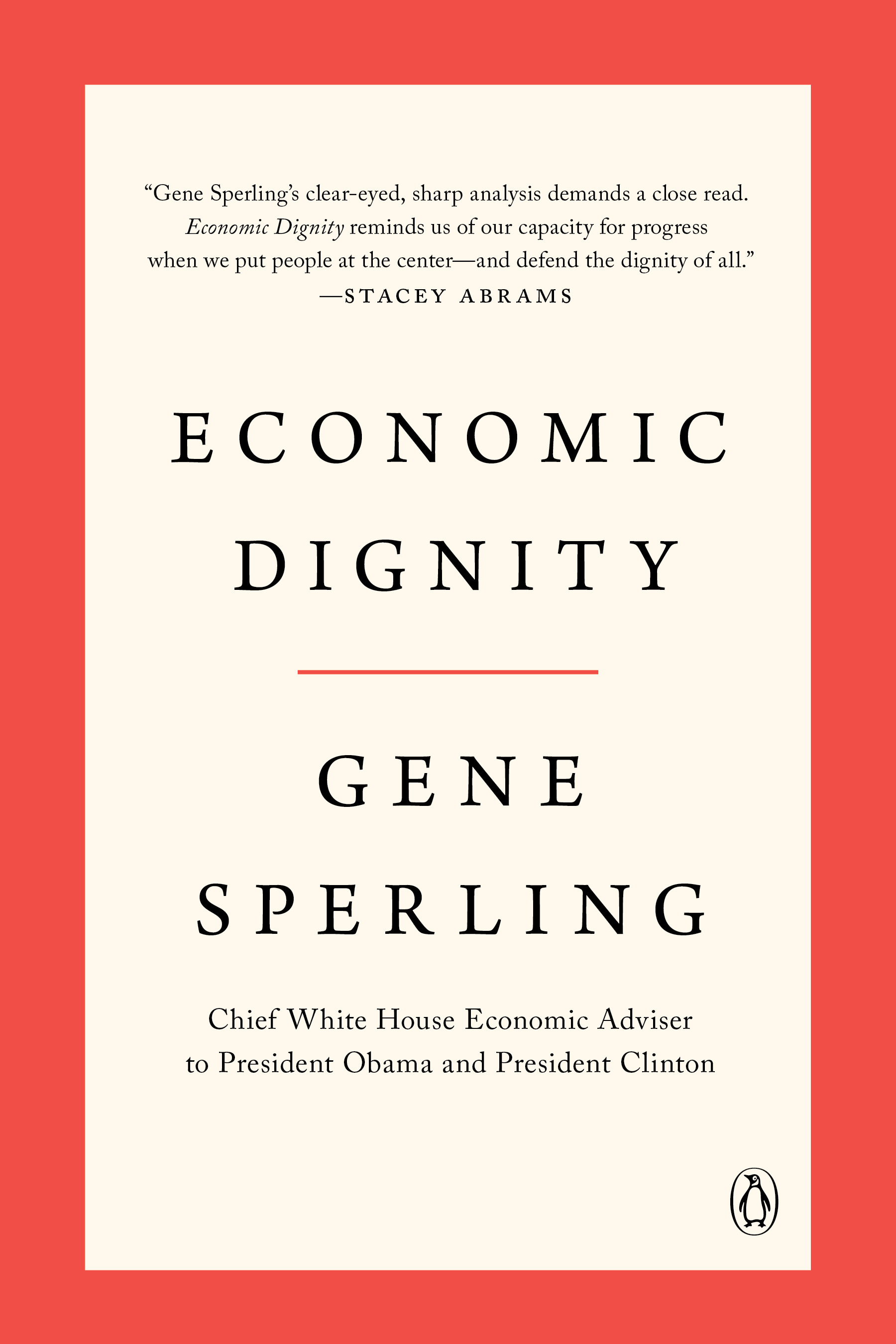
Economic Dignity “A timely and important new book…It should be our North Star for the recovery and beyond.” -Hillary Clinton From one of our wisest and most influential economic thinkers, the only person to serve as Director of the National Economic Council under two Presidents, a profound big-picture vision of why the promotion of dignity should be the singular end goal by which we chart America's economic future When Gene Sperling was in charge of coordinating the shaping and execution of the US government's economic policy in the Obama White House, he found himself surprised and dismayed when serious people in Washington worried out loud to him that the Obama focus on health care was a distraction because it was "not focused on the economy." How, he asked, was millions of Americans' fear that they were a single pink slip or a loved one's serious illness away from financial ruin somehow not considered an economic issue? To him, it was just one more example of a more profound truth he witnessed in his many years in our national economic debate: that when it comes to America's economic policy, there is too little focus on what the end goal should be. Too often, he found that our economic debate confused ends and means; that we measured economic success by metrics like GDP instead of whether the economy was succeeding in lifting up the sense of meaning, purpose, fulfillment, and security of people. Too often, he found debates framed by old divisions or pro-market ideology that increasingly failed to capture whether economic policy was fostering exploitation, economic insecurity, and disillusionment that were too often invisible within our current framework. Now more than ever, at a moment when the very capacity of modern capitalism to avoid accelerating inequality, a hollowed-out middle class, and structural poverty is being questioned, we need to step back and reflect on our ultimate goals. Economic Dignity is Sperling's effort to do just that - to frame our thinking about the way forward in a time of wrenching economic change. His argument combines moral and intellectual seriousness with actual high-level policy experience. Economic dignity, Sperling maintains, can be seen as resting on three pillars. The first: the capacity to care for family without economic deprivation denying people the capacity to experience its greatest joys - the birth of one's children, the companionship of a loving partner, the love of family and friends, the fulfillment that comes from providing. The second: the right to the pursuit of potential and purpose, including the right to first and second chances - the right to a life of active striving. The third: economic participation with respect and without domination and humiliation. All three pillars are rooted in the highest and most noble values of the American project. But getting there is the rub, and in Economic Dignity, Sperling offers paths that policymakers and citizens can follow for years to come. As he puts it, if you live in times when major steps forward are needed, it is important to be clear on your destination - or at least to know the North Star that is guiding you. His answer, in two words, is economic dignity. POLITICAL SCIENCE,Public Policy,Economic Policy
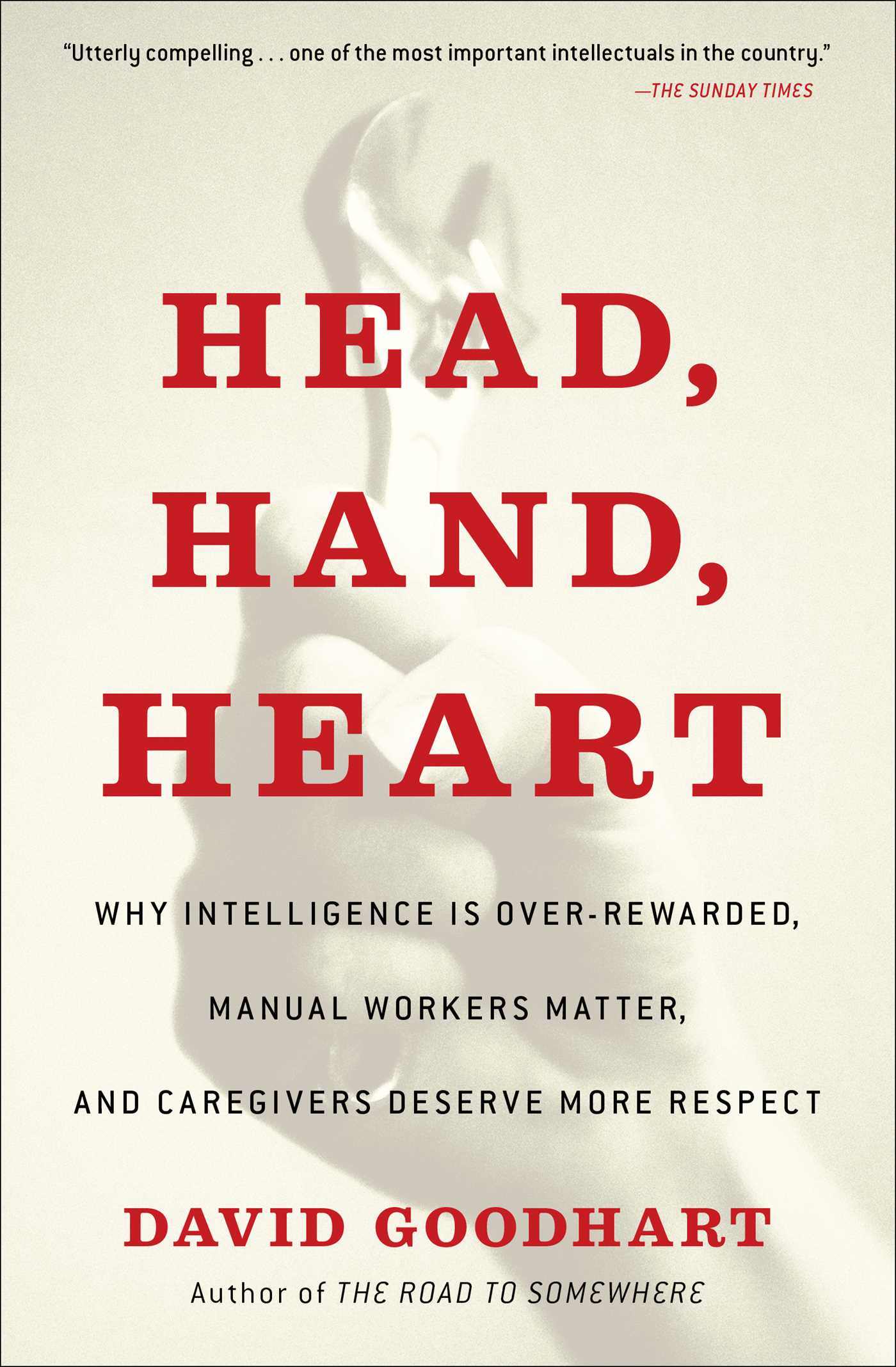
Head, Hand, Heart A TIMELY AND PROVOCATIVE ARGUMENT FROM LEADING POLITICAL ANALYST DAVID GOODHART ABOUT THE SEVERELY IMBALANCED DISTRIBUTION OF STATUS AND WORK IN WESTERN SOCIETIES. The coronavirus pandemic revealed what we ought to have already known: that nurses, caregivers, supermarket workers, delivery drivers, cleaners, and so many others are essential. Until recently, this work was largely regarded as menial by the same society that now lauds them as heroes. How did we get here? In his groundbreaking follow-up to the bestselling The Road to Somewhere, David Goodhart divides society into people who work with their Heads (cognitive work), with their Hands (manual work), or with their Hearts (caring work), and considers each group’s changing status and influence. Today, the “the best and the brightest†trump the “decent and hardworking.†Qualities like character, compassion, craft, and physical labor command far less respect in our workforce. This imbalance has led to the disaffection and alienation of millions of people. David Goodhart reveals the untold history behind this disparity and outlines the challenges we face as a result. Cognitive ability has become the gold standard of human esteem, and those in the cognitive class now shape society largely in their own interest. To put it bluntly: smart people have become too powerful. A healthy democratic society respects and rewards a broad range of achievement, and provides meaning and value for people who cannot—or do not want to—achieve in the classroom and professional career market. We must shift our thinking to see all workers as essential, and not just during crises like the coronavirus pandemic. This is the dramatic story of the struggle for status and dignity in the 21st century. POLITICAL SCIENCE,Public Policy,Economic Policy

Liberty from All Masters Barry C. Lynn, one of America's preeminent thinkers, provides the clearest statement yet on the nature and magnitude of the political and economic dangers posed by America’s new monopolies in Liberty from All Masters. "Very few thinkers in recent years have done more to shift the debate in Washington than Barry Lynn."—Franklin Foer Americans are obsessed with liberty, mad about liberty. On any day, we can tune into arguments about how much liberty we need to buy a gun or get an abortion, to marry who we want or adopt the gender we feel. We argue endlessly about liberty from regulation and observation by the state, and proudly rebel against the tyranny of course syllabi and Pandora playlists. Redesign the penny today and the motto would read “You ain’t the boss of me.†Yet Americans are only now awakening to what is perhaps the gravest domestic threat to our liberties in a century—in the form of an extreme and fast-growing concentration of economic power. Monopolists today control almost every corner of the American economy. The result is not only lower wages and higher prices, hence a concentration of wealth and power in the hands of the few. The result is also a stripping away of our liberty to work how and where we want, to launch and grow the businesses we want, to create the communities and families and lives we want. The rise of online monopolists such as Google and Amazon—designed to gather our most intimate secrets and use them to manipulate our personal and group actions—is making the problem only far worse fast. Not only have these giant corporations captured the ability to manage how we share news and ideas with one another, they increasingly enjoy the power to shape how we move and play and speak and think. POLITICAL SCIENCE,Public Policy,Economic Policy
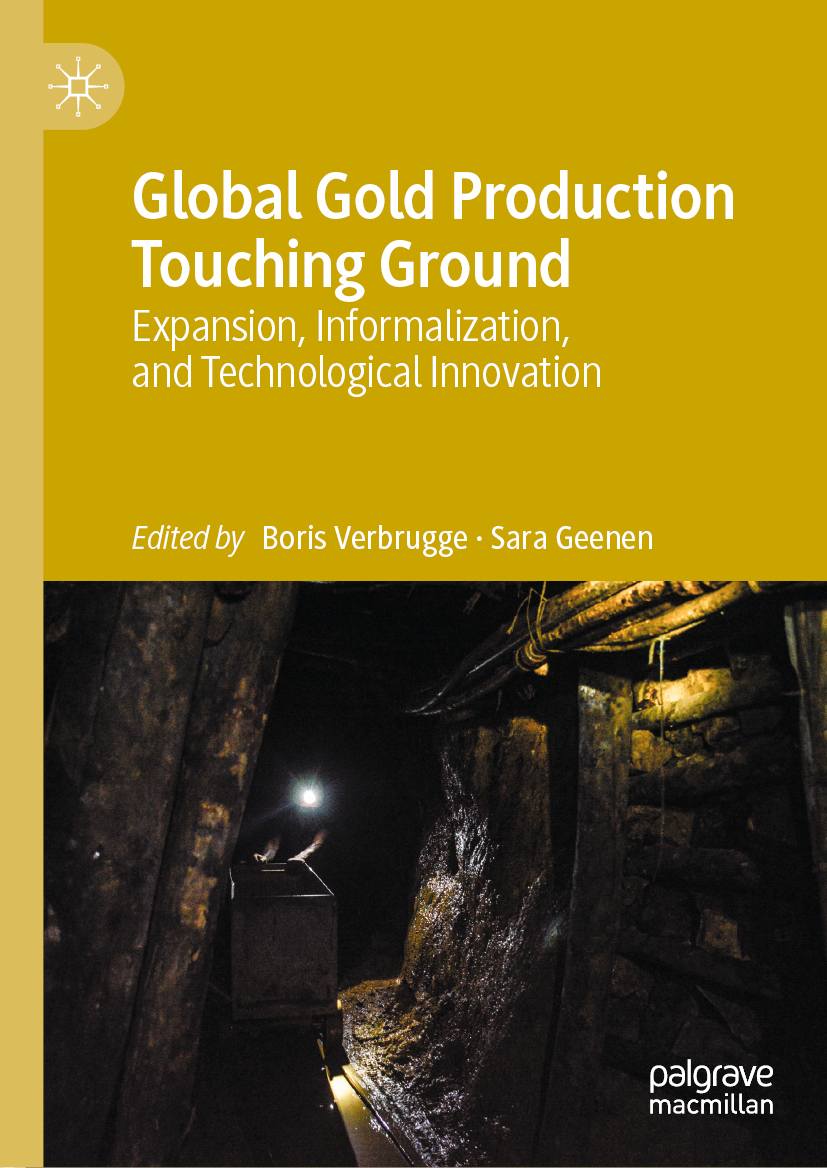
Global Gold Production Touching Ground In recent decades, gold mining has moved into increasingly remote corners of the globe. Aside from the expansion of industrial gold mining, many countries have simultaneously witnessed an expansion of labor-intensive and predominantly informal artisanal and small-scale gold mining. Both trends are usually studied in isolation, which contributes to a dominant image of a dual gold mining economy. Counteracting this dominant view, this volume adopts a global perspective, and demonstrates that both industrial gold mining and artisanal and small-scale gold mining are functionally integrated into a global gold production system. It couples an analysis of structural trends in global gold production (expansion, informalization, and technological innovation) to twelve country case studies that detail how global gold production becomes embedded in institutional and ecological structures. POLITICAL SCIENCE,Public Policy,Economic Policy
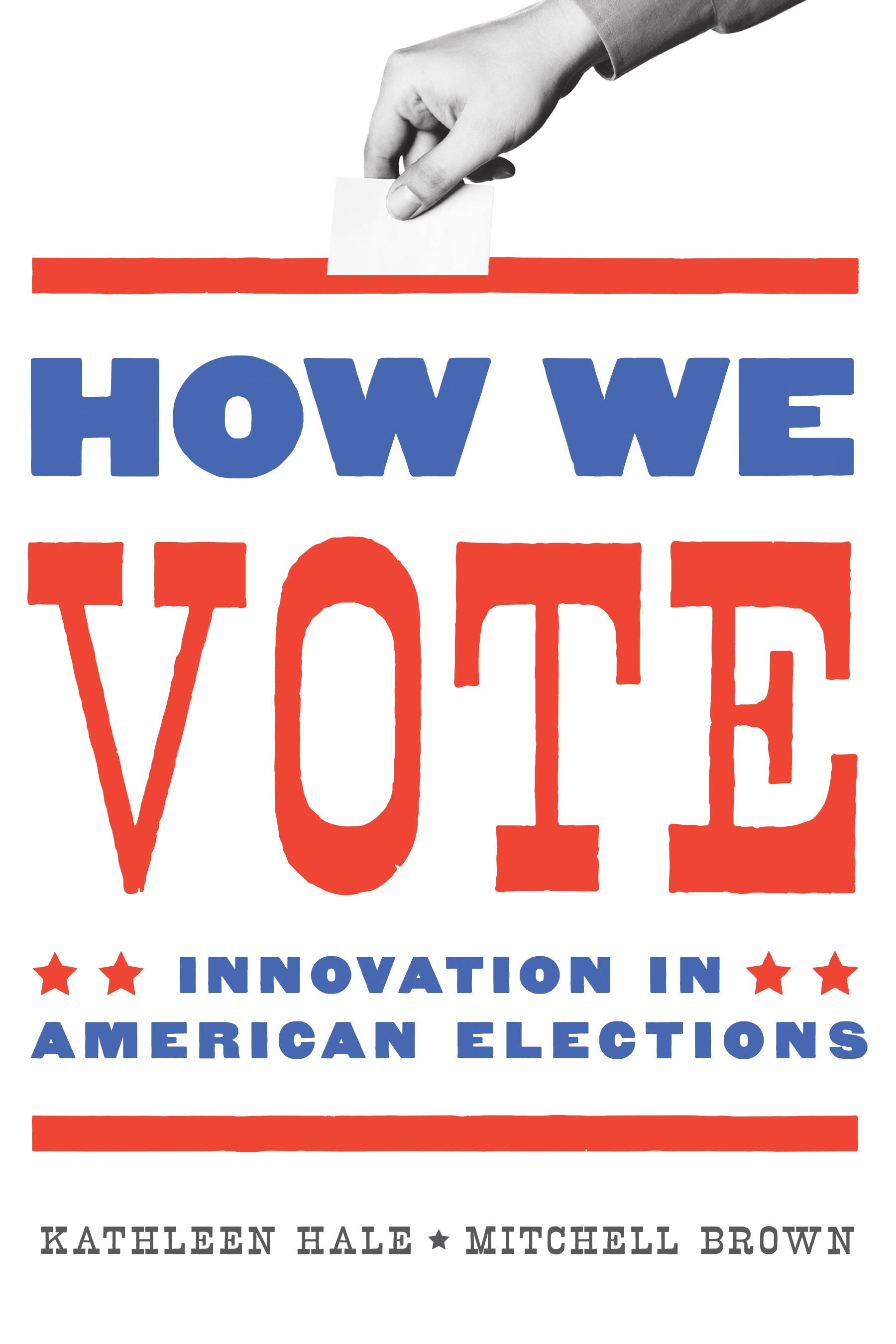
How We Vote The idea of voting is simple, but the administration of elections in ways that ensure access and integrity is complex. In How We Vote, Kathleen Hale and Mitchell Brown explore how election officials work, how ballots are cast and counted, and how jurisdictions try to innovate while also protecting the security of the voting process. Election officials must work in a difficult intergovernmental environment of constant change and intense partisanship. Voting practices and funding vary from state to state, and multiple government agencies, the judicial system, voting equipment vendors, nonprofit groups, and citizen activists also influence practices and limit change. Despite real challenges and pessimistic media assessments, Hale and Brown demonstrate that election officials are largely successful in their work to facilitate, protect, and evolve the voting process. Using original data gathered from state and local election officials and policymakers across the United States, Hale and Brown analyze innovations in voter registration, voting options, voter convenience, support for voting in languages other than English, the integrity of the voting process, and voting system technology. The result is a fascinating picture of how we vote now and will vote in the future. POLITICAL SCIENCE,Public Policy,Economic Policy

The Case for a Job Guarantee One of the most enduring ideas in economics is that unemployment is both unavoidable and necessary for the smooth functioning of the economy. This assumption has provided cover for the devastating social and economic costs of job insecurity. It is also false. In this book, leading expert Pavlina R. Tcherneva challenges us to imagine a world where the phantom of unemployment is banished and anyone who seeks decent, living-wage work can find it - guaranteed. This is the aim of the Job Guarantee proposal: to provide a voluntary employment opportunity in public service to anyone who needs it. Tcherneva enumerates the many advantages of the Job Guarantee over the status quo and proposes a blueprint for its implementation within the wider context of the need for a Green New Deal. This compact primer is the ultimate guide to the benefits of one of the most transformative public policies being discussed today. It is essential reading for all citizens and activists who are passionate about social justice and building a fairer economy. POLITICAL SCIENCE,Public Policy,Economic Policy
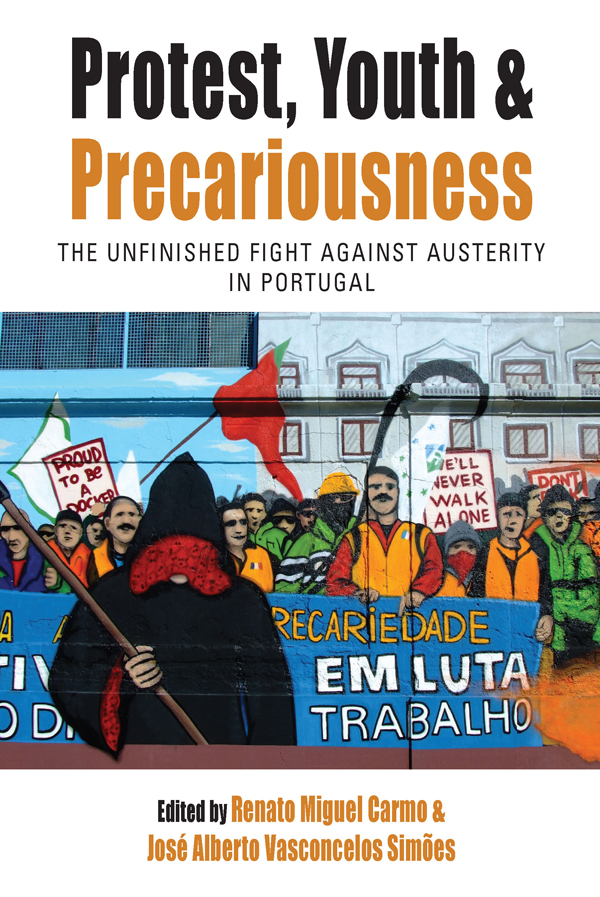
Protest, Youth and Precariousness After over a decade of the austerity measures that followed the 2008 financial crisis—entailing severe, unpopular policies that have galvanized opposition and frayed social ties—what lies next for European societies? Portugal offers an interesting case for exploring this question, as a nation that was among the hardest hit by austerity and is now seeking a fresh path forward. This collection brings together sociologists, social movement specialists, political scientists, and other scholars to look specifically at how Portuguese youth have navigated this politically and economically difficult period, negotiating uncertain social circumstances as they channel their discontent into protest and collective action. POLITICAL SCIENCE,Public Policy,Economic Policy

The Political Economy of Participatory Economics With the near bankruptcy of centrally planned economies now apparent and with capitalism seemingly incapable of generating egalitarian outcomes in the first world and economic development in the third world, alternative approaches to managing economic affairs are an urgent necessity. Until now, however, descriptions of alternatives have been unconvincing. Here Michael Albert and Robin Hahnel support the libertarian socialist tradition by presenting a rigorous, well-defined model of how producers and consumers could democratically plan their interconnected activities. After explaining why hierarchical production, inegalitarian consumption, central planning, and market allocations are incompatible with "classlessness," the authors present an alternative model of democratic workers' and consumers' councils operating in a decentralized, social planning procedure. They show how egalitarian consumption and job complexes in which all engage in conceptual as well as executionary labor can be efficient. They demonstrate the ability of their planning procedure to yield equitable and efficient outcomes even in the context of externalities and public goods and its power to stimulate rather than subvert participatory impulses. Also included is a discussion of information management and how simulation experiments can substantiate the feasibility of their model. POLITICAL SCIENCE,Public Policy,Economic Policy
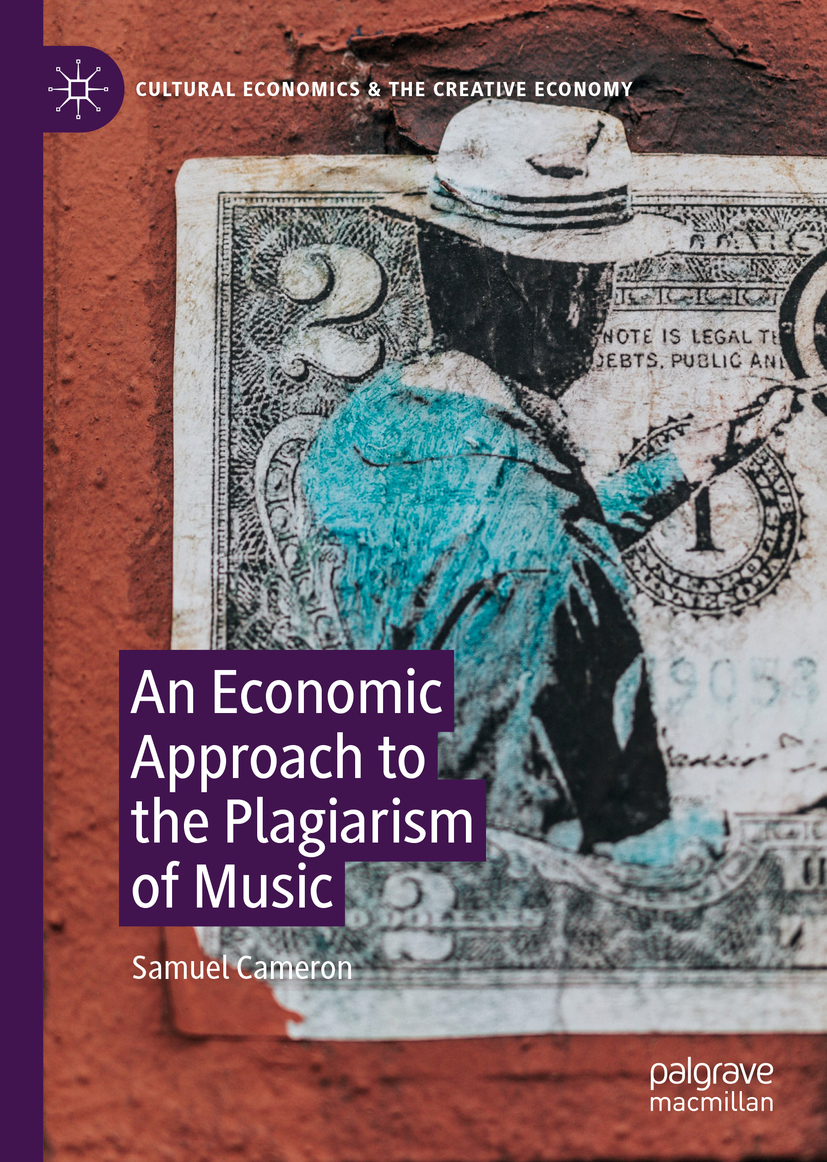
An Economic Approach to the Plagiarism of Music This book is an economic analysis of plagiarism in music, focusing on social efficiency and questions of inequity in the revenue of authors/artists. The organisation into central chapters on the traditional literary aspect of composition and the technocratic problem of ‘sampling’ will help clarify disputes about social efficiency and equity. It will also be extremely helpful as an expository method where the text is used in courses on the music business.These issues have been explored to a great extent in other areas of musical content—notably piracy, copying and streaming. Therefore it is extremely helpful to exclude consumer use of musical content from the discussion to focus solely on the production side. This book also looks at the policy options in terms of the welfare economics of policy analysis. POLITICAL SCIENCE,Public Policy,Economic Policy
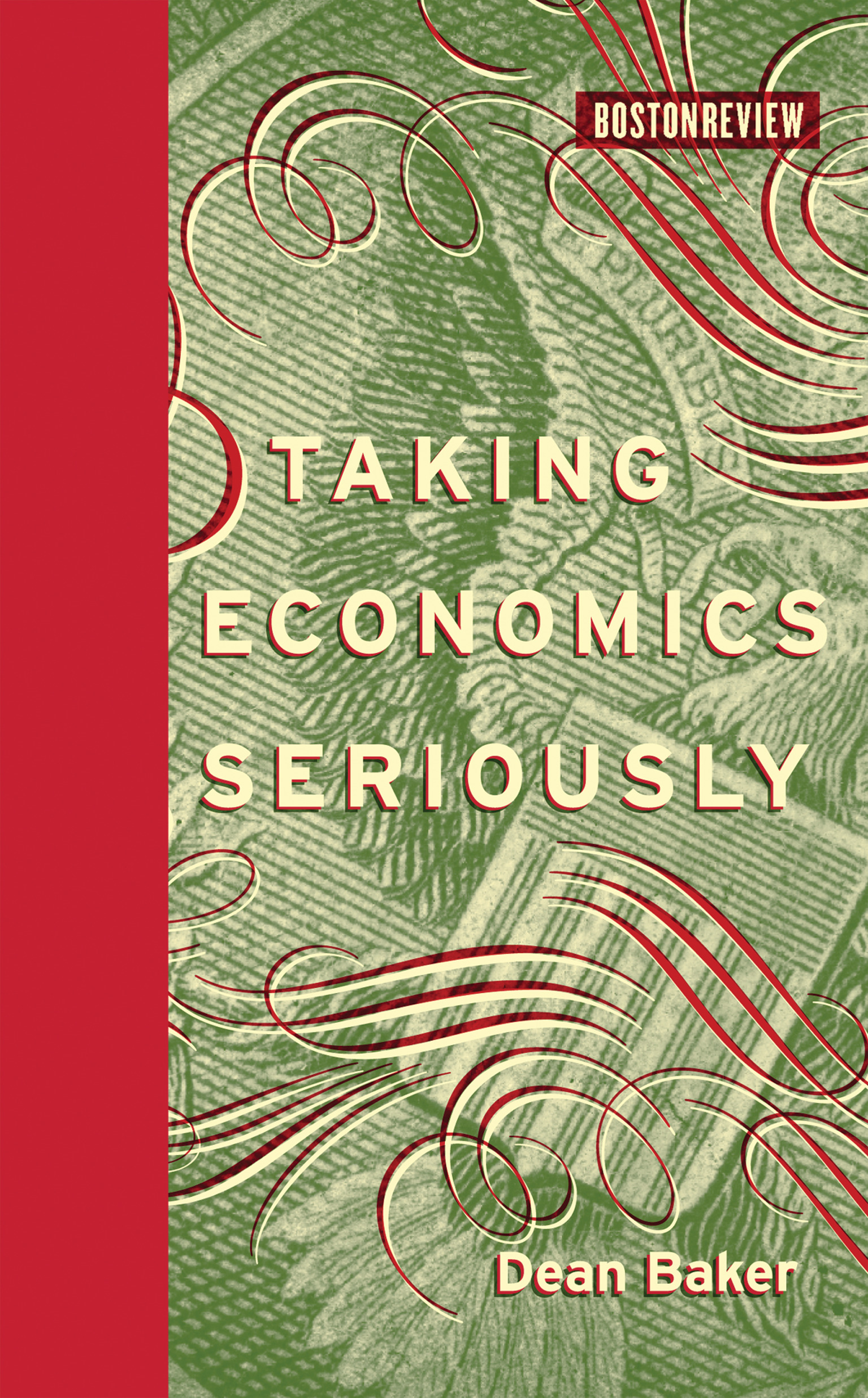
Taking Economics Seriously A leading economist's exploration of what our economic arrangements might look like if we applied basic principles without ideological blinders. There is nothing wrong with economics, Dean Baker contends, but economists routinely ignore their own principles when it comes to economic policy. What would policy look like if we took basic principles of mainstream economics seriously and applied them consistently? In the debate over regulation, for example, Baker—one of the few economists who predicted the meltdown of fall 2008—points out that ideological blinders have obscured the fact there is no “free market” to protect. Modern markets are highly regulated, although intrusive regulations such as copyright and patents are rarely viewed as regulatory devices. If we admit the extent to which the economy is and will be regulated, we have many more options in designing policy and deciding who benefits from it. On health care reform, Baker complains that economists ignore another basic idea: marginal cost pricing. Unlike all other industries, medical services are priced extraordinarily high, far above the cost of production, yet that discrepancy is rarely addressed in the debate about health care reform. What if we applied marginal cost pricing—making doctors' wages competitive and charging less for prescription drugs and tests such as MRIs? Taking Economics Seriously offers an alternative Econ 101. It introduces economic principles and thinks through what we might gain if we free ourselves from ideological blinders and get back to basics in the most troubled parts of our economy. POLITICAL SCIENCE,Public Policy,Economic Policy
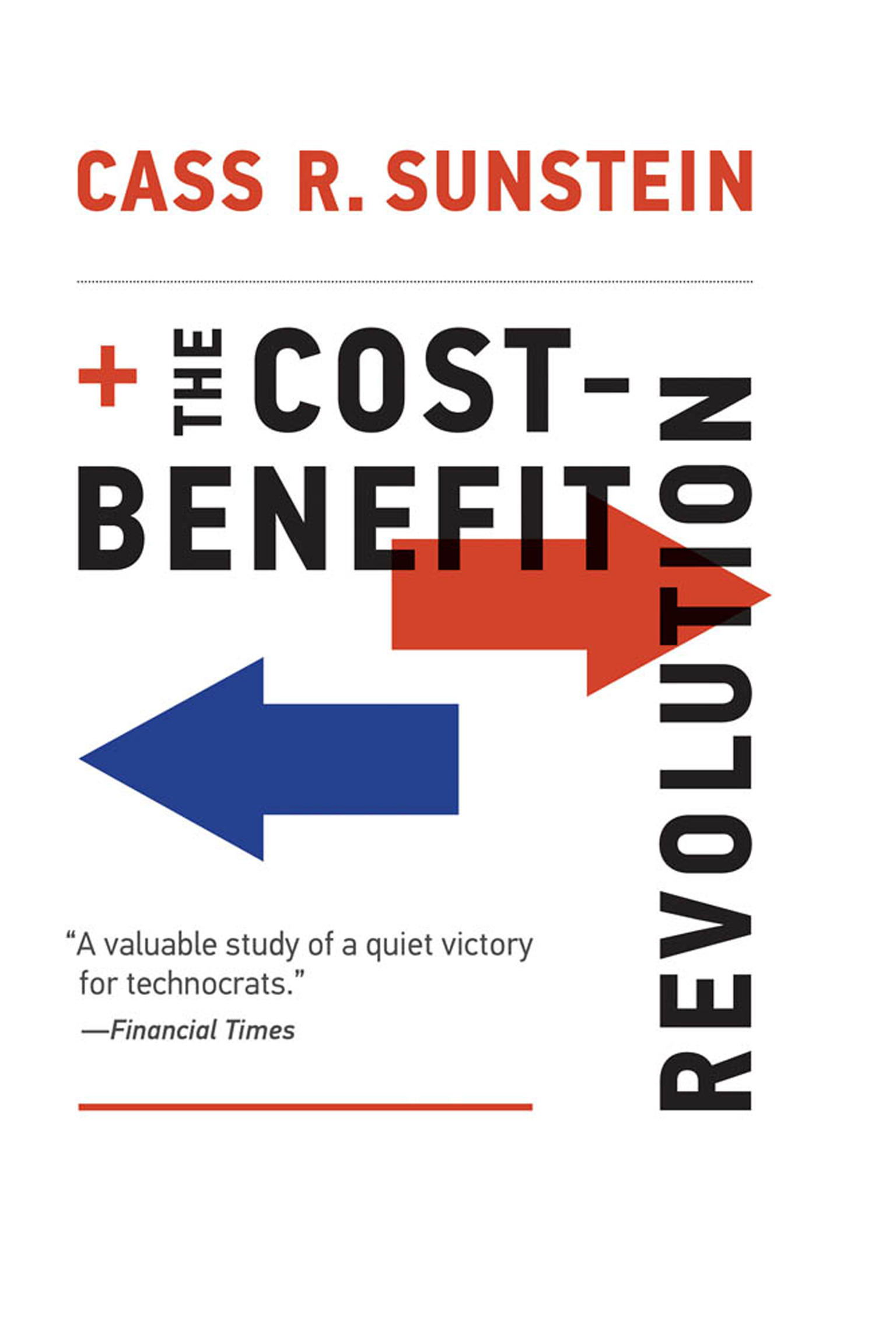
The Cost-Benefit Revolution Why policies should be based on careful consideration of their costs and benefits rather than on intuition, popular opinion, interest groups, and anecdotes. Opinions on government policies vary widely. Some people feel passionately about the child obesity epidemic and support government regulation of sugary drinks. Others argue that people should be able to eat and drink whatever they like. Some people are alarmed about climate change and favor aggressive government intervention. Others don't feel the need for any sort of climate regulation. In The Cost-Benefit Revolution, Cass Sunstein argues our major disagreements really involve facts, not values. It follows that government policy should not be based on public opinion, intuitions, or pressure from interest groups, but on numbers—meaning careful consideration of costs and benefits. Will a policy save one life, or one thousand lives? Will it impose costs on consumers, and if so, will the costs be high or negligible? Will it hurt workers and small businesses, and, if so, precisely how much? As the Obama administration's “regulatory czar,” Sunstein knows his subject in both theory and practice. Drawing on behavioral economics and his well-known emphasis on “nudging,” he celebrates the cost-benefit revolution in policy making, tracing its defining moments in the Reagan, Clinton, and Obama administrations (and pondering its uncertain future in the Trump administration). He acknowledges that public officials often lack information about costs and benefits, and outlines state-of-the-art techniques for acquiring that information. Policies should make people's lives better. Quantitative cost-benefit analysis, Sunstein argues, is the best available method for making this happen—even if, in the future, new measures of human well-being, also explored in this book, may be better still. POLITICAL SCIENCE,Public Policy,Economic Policy
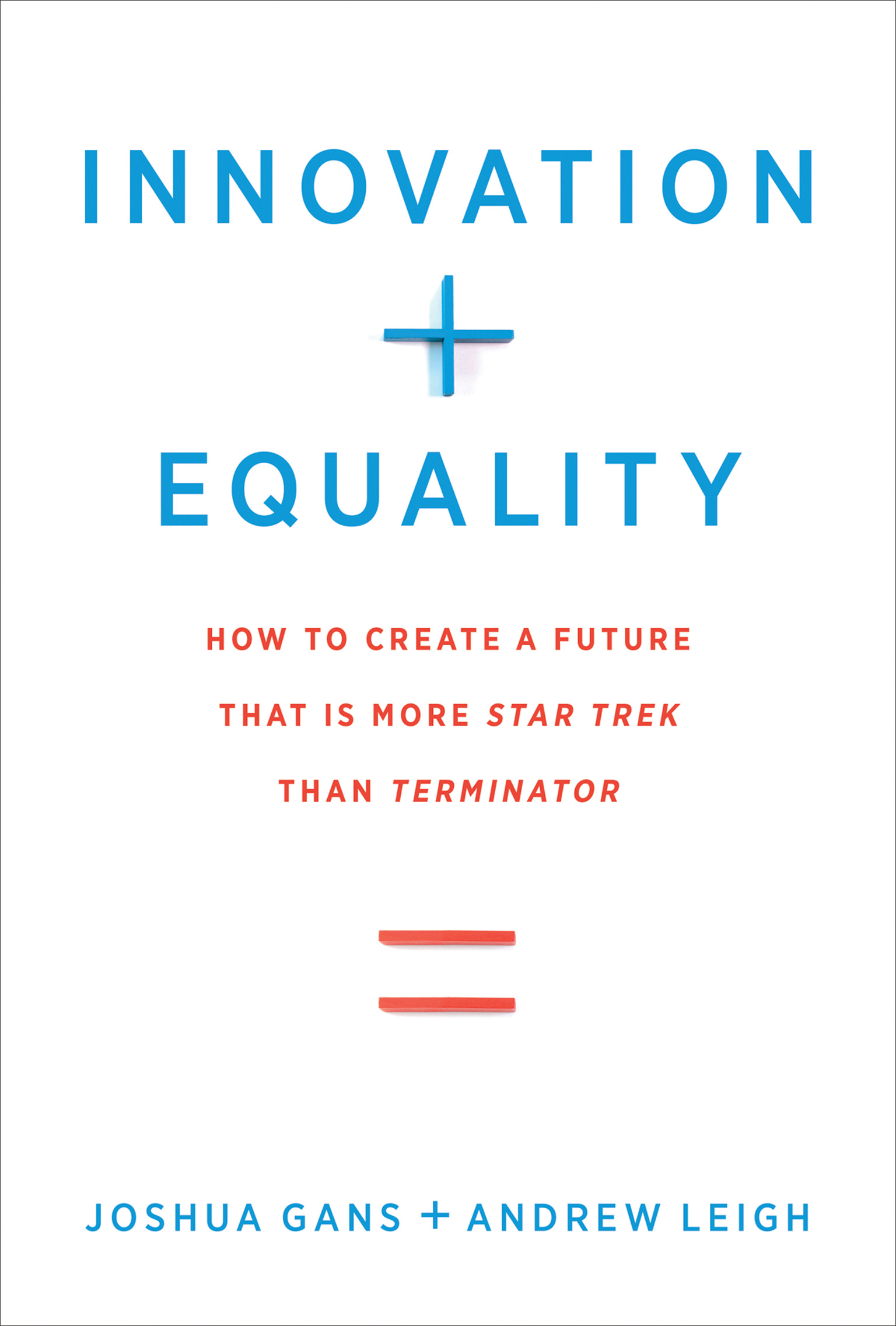
Innovation + Equality How to get more innovation and more equality. Is economic inequality the price we pay for innovation? The amazing technological advances of the last two decades—in such areas as artificial intelligence, genetics, and materials—have benefited society collectively and rewarded innovators handsomely: we get cool smartphones and technology moguls become billionaires. This contributes to a growing wealth gap; in the United States; the wealth controlled by the top 0.1 percent of households equals that of the bottom ninety percent. Is this the inevitable cost of an innovation-driven economy? Economist Joshua Gans and policy maker Andrew Leigh make the case that pursuing innovation does not mean giving up on equality—precisely the opposite. In this book, they outline ways that society can become both more entrepreneurial and more egalitarian. All innovation entails uncertainty; there's no way to predict which new technologies will catch on. Therefore, Gans and Leigh argue, rather than betting on the future of particular professions, we should consider policies that embrace uncertainty and protect people from unfavorable outcomes. To this end, they suggest policies that promote both innovation and equality. If we encourage innovation in the right way, our future can look more like the cheerful techno-utopia of Star Trek than the dark techno-dystopia of The Terminator. POLITICAL SCIENCE,Public Policy,Economic Policy

Profits and Prophets This book is a study of potential, perceived, and real conflicts and similarities between market economics and Jewish social justice. The book’s ultimate focus is on public policy issues. In the first two chapters, the author presents the conceptual and theoretical foundations of market economics and Jewish social justice. Subsequent chapters analyze minimum wage, immigration, climate change, and usury from both market economics and Jewish social justice perspectives, discussing conflicts, and, if they exist, similarities. POLITICAL SCIENCE,Public Policy,Economic Policy
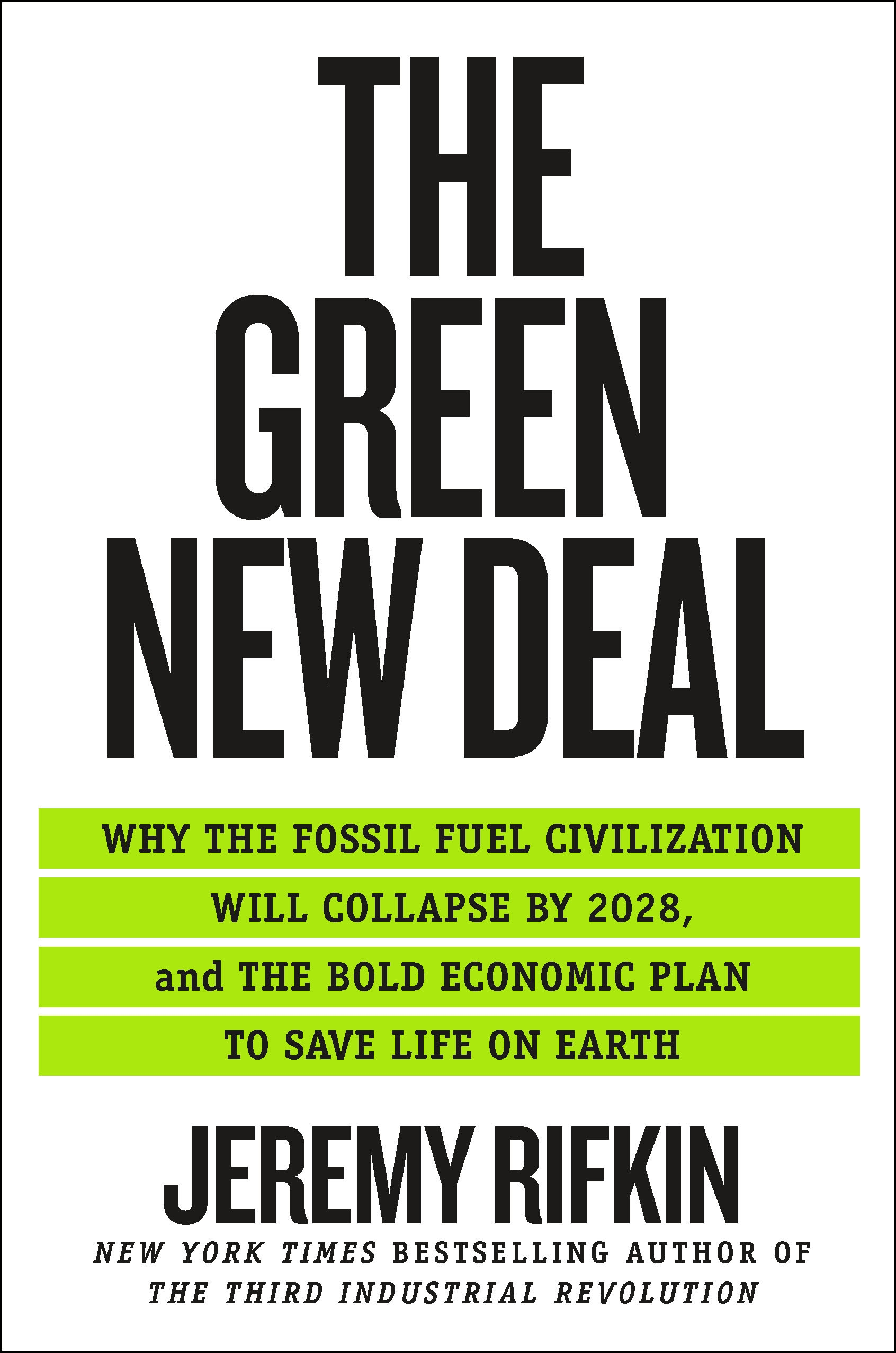
The Green New Deal An urgent plan to confront climate change, transform the American economy, and create a green post-fossil fuel culture. A new vision for America’s future is quickly gaining momentum. Facing a global emergency, a younger generation is spearheading a national conversation around a Green New Deal and setting the agenda for a bold political movement with the potential to revolutionize society. Millennials, the largest voting bloc in the country, are now leading on the issue of climate change. While the Green New Deal has become a lightning rod in the political sphere, there is a parallel movement emerging within the business community that will shake the very foundation of the global economy in coming years. Key sectors of the economy are fast-decoupling from fossil fuels in favor of ever cheaper solar and wind energies and the new business opportunities and employment that accompany them. New studies are sounding the alarm that trillions of dollars in stranded fossil fuel assets could create a carbon bubble likely to burst by 2028, causing the collapse of the fossil fuel civilization. The marketplace is speaking, and governments will need to adapt if they are to survive and prosper. In The Green New Deal, New York Times bestselling author and renowned economic theorist Jeremy Rifkin delivers the political narrative and economic plan for the Green New Deal that we need at this critical moment in history. The concurrence of a stranded fossil fuel assets bubble and a green political vision opens up the possibility of a massive shift to a post-carbon ecological era, in time to prevent a temperature rise that will tip us over the edge into runaway climate change. With twenty-five years of experience implementing Green New Deal–style transitions for both the European Union and the People’s Republic of China, Rifkin offers his vision for how to transform the global economy and save life on Earth. POLITICAL SCIENCE,Public Policy,Energy Policy

Alternative Energy A supplemental text for upper-division and graduate courses on environmental or energy politics/policy offered in departments of political science as well as Masters in Public Policy programs. POLITICAL SCIENCE,Public Policy,Energy Policy

Goldilocks Policy, The 'The author leavens his discussion of a transition to a sustainable energy mix with the views of three prominent energy experts; following this is an introduction to ‘Goldilocks policy’ and a detailed discussion of its obstacles. The author stresses the importance of factoring in capacity, cost, safety, reliability, and environmental effects in developing a sustainable energy policy.'CHOICEThis book makes the case for a grand energy bargain that recognizes the need to protect the environment from the combustion of fossil fuels while protecting the national and global economies during the transition from fossil fuels to sustainable energy.Our future energy mix depends on choices we make, which depends, in turn, on energy policy. Society is continuing a trend toward decarbonization: the reduction in the relative amount of carbon in combustible fuels. The 21st century energy mix will depend on technological advances, including some advances that cannot be anticipated, and on choices made by society.There are competing visions for reaching a sustainable energy mix. If the energy transition is too fast, it could significantly damage the global economy. If the energy transition is too slow, damage to the environment could be irreversible.The 'Goldilocks Policy for Energy Transition' is designed to establish a middle ground between these competing visions. We need the duration of the energy transition to be just right; we need to adopt a reasonable plan of action that reduces uncertainty for businesses and innovators with predictable public policy while simultaneously minimizing environmental impact.The question of climate change is still unsettled, but enough is known to motivate a transition away from fossil fuels. The transition does not have to be abrupt and catastrophic, however. Historical energy transitions can be a guide to a reasonable duration for making an orderly transition. If we exercise discipline and patience, we can overcome the obstacles to successful implementation of a grand energy bargain. POLITICAL SCIENCE,Public Policy,Energy Policy
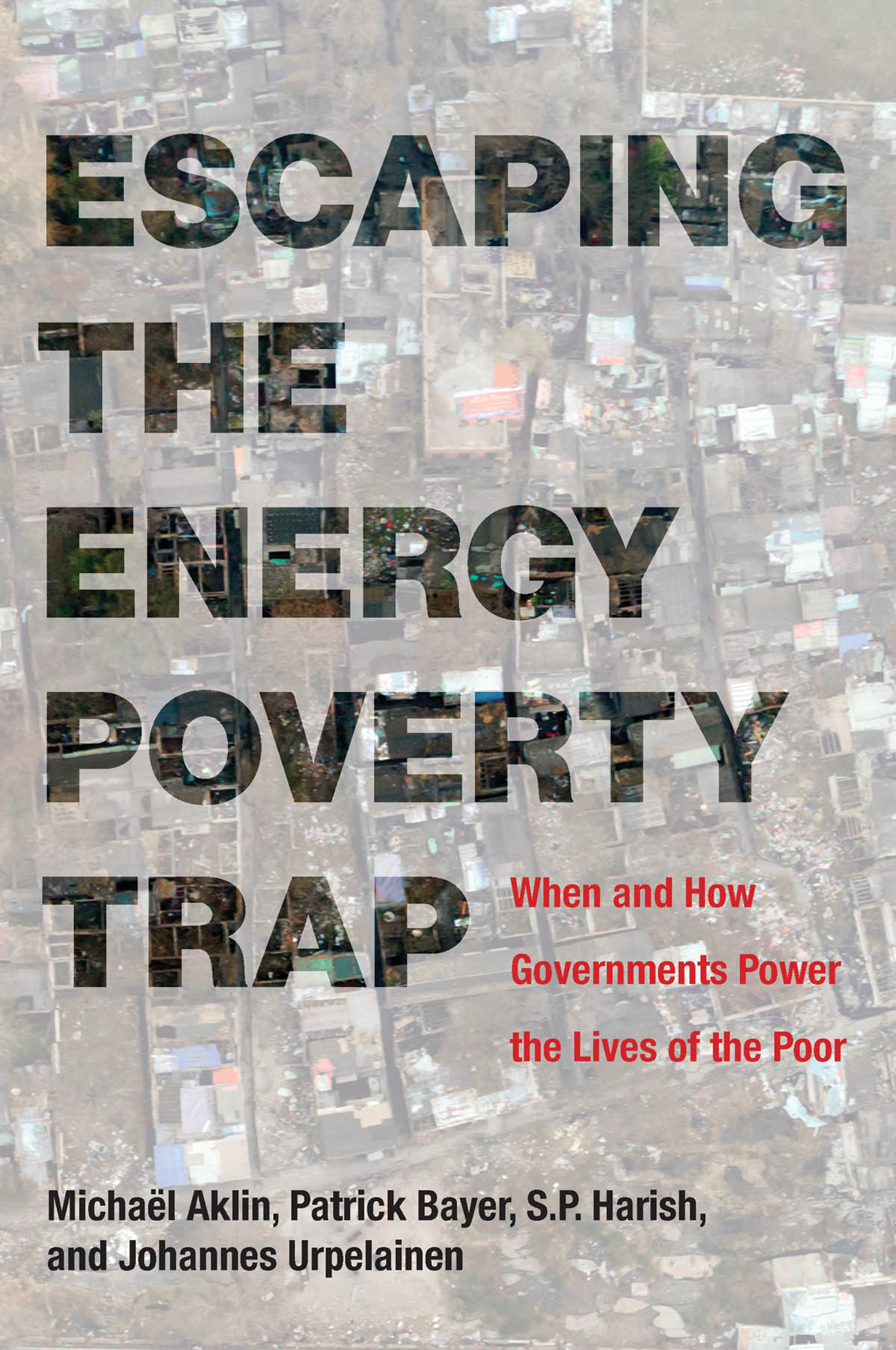
Escaping the Energy Poverty Trap The first comprehensive political science account of energy poverty, arguing that governments can improve energy access for their citizens through appropriate policy design. In today's industrialized world, almost everything we do consumes energy. While industrialized countries enjoy all the amenities of modern energy, more than a billion people in the developing world still lack energy access. Why is energy poverty persistent in some countries and not in others? Offering the first comprehensive political science account of energy poverty, Escaping the Energy Poverty Trap explores why governments have or have not been able to lead in providing modern energy to their least advantaged citizens. Focusing on access to modern cooking fuels and household electrification, the authors develop a new political-economic theory that introduces government interest, institutional capacity, and local accountability as key determinants of energy access. They draw on case studies from India, East Asia, Africa, and Latin America to offer the optimistic conclusion that governments can improve institutional capacity and local accountability through appropriate policy design. Energy poverty is a policy problem, the authors assert, and engaging with it as such offers new opportunities not only for ensuring equal energy access, but also for political, economic, and environmental development. POLITICAL SCIENCE,Public Policy,Energy Policy
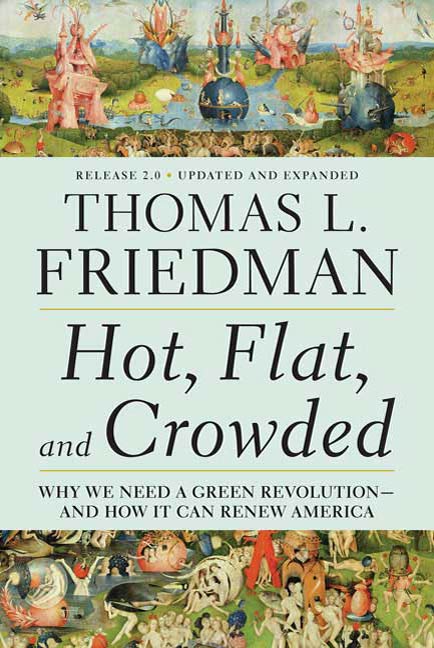
Hot, Flat, and Crowded 2.0 A New York Times Book Review Notable Book of the Year A Washington Post Best Book of the Year A Businessweek Best Business Book of the Year A Chicago Tribune Best Book of the Year In this brilliant, essential book, Pulitzer Prize-winning author Thomas L. Friedman speaks to America's urgent need for national renewal and explains how a green revolution can bring about both a sustainable environment and a sustainable America. Friedman explains how global warming, rapidly growing populations, and the expansion of the world's middle class through globalization have produced a dangerously unstable planet--one that is "hot, flat, and crowded." In this Release 2.0 edition, he also shows how the very habits that led us to ravage the natural world led to the meltdown of the financial markets and the Great Recession. The challenge of a sustainable way of life presents the United States with an opportunity not only to rebuild its economy, but to lead the world in radically innovating toward cleaner energy. And it could inspire Americans to something we haven't seen in a long time--nation-building in America--by summoning the intelligence, creativity, and concern for the common good that are our greatest national resources. Hot, Flat, and Crowded is classic Thomas L. Friedman: fearless, incisive, forward-looking, and rich in surprising common sense about the challenge--and the promise--of the future. POLITICAL SCIENCE,Public Policy,Environmental Policy

Environment and Society Environment and Society: A Critical Introduction is an overview of the diverse conceptual tools and traditions for thinking about, explaining and addressing the environmental challenges we face in the contemporary world. Provides an introduction to the environmental challenges we face in the contemporary world through foundational theoretical ideas illustrated with concrete, everyday examples Utilizes compelling, conversational language to expound on theory, history, and scientific topics, making the text accessible to a diverse readership Draws upon contemporary theoretical understandings in nature/society theory while demonstrating through practice and deployment Includes discussion of key historical events, topical issues, and policies, as well as scientific concepts POLITICAL SCIENCE,Public Policy,Environmental Policy
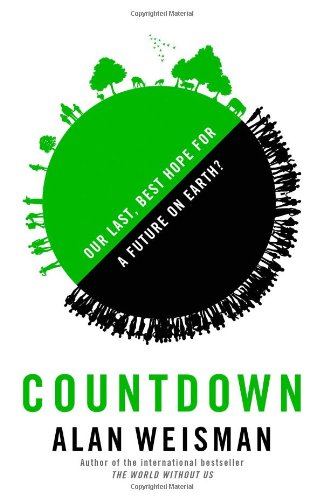
Countdown A powerful investigation into the chances for humanity's future from the author of the bestseller The World Without Us. In his bestselling book The World Without Us, Alan Weisman considered how the Earth could heal and even refill empty niches if relieved of humanity's constant pressures. Behind that groundbreaking thought experiment was his hope that we would be inspired to find a way to add humans back to this vision of a restored, healthy planet-only in harmony, not mortal combat, with the rest of nature. But with a million more of us every 4 1/2 days on a planet that's not getting any bigger, and with our exhaust overheating the atmosphere and altering the chemistry of the oceans, prospects for a sustainable human future seem ever more in doubt. For this long awaited follow-up book, Weisman traveled to more than 20 countries to ask what experts agreed were probably the most important questions on Earth -- and also the hardest: How many humans can the planet hold without capsizing? How robust must the Earth's ecosystem be to assure our continued existence? Can we know which other species are essential to our survival? And, how might we actually arrive at a stable, optimum population, and design an economy to allow genuine prosperity without endless growth? Weisman visits an extraordinary range of the world's cultures, religions, nationalities, tribes, and political systems to learn what in their beliefs, histories, liturgies, or current circumstances might suggest that sometimes it's in their own best interest to limit their growth. The result is a landmark work of reporting: devastating, urgent, and, ultimately, deeply hopeful. By vividly detailing the burgeoning effects of our cumulative presence, Countdown reveals what may be the fastest, most acceptable, practical, and affordable way of returning our planet and our presence on it to balance. Weisman again shows that he is one of the most provocative journalists at work today, with a book whose message is so compelling that it will change how we see our lives and our destiny. POLITICAL SCIENCE,Public Policy,Environmental Policy
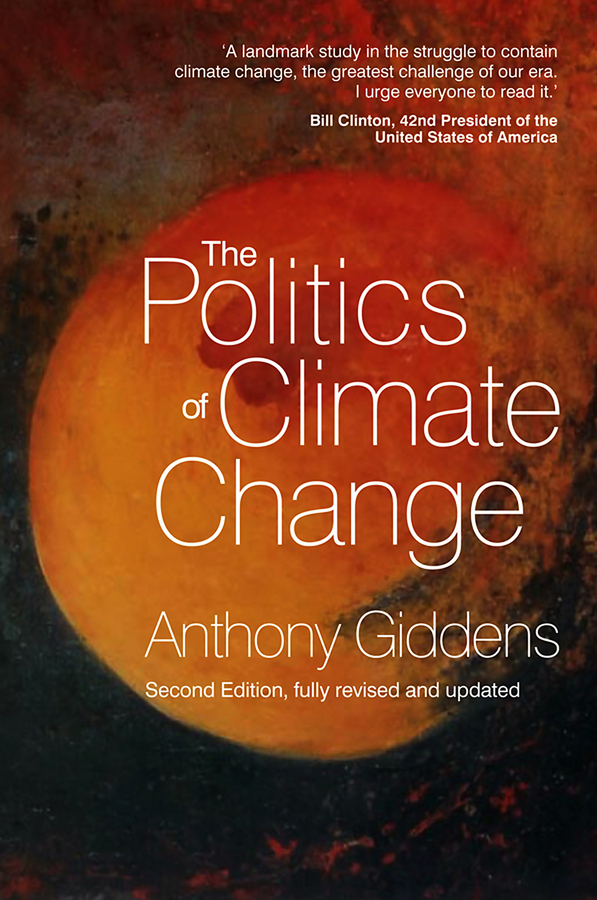
The Politics of Climate Change "A landmark study in the struggle to contain climate change, the greatest challenge of our era. I urge everyone to read it." Bill Clinton, 42nd President of the United States of America Since it first appeared, this book has achieved a classic status. Reprinted many times since its publication, it remains the only work that looks in detail at the political issues posed by global warming. This new edition has been thoroughly updated and provides a state-of-the-art discussion of the most formidable challenge humanity faces this century. If climate change goes unchecked, the consequences are likely to be catastrophic for human life on earth. Yet for most people and for many policy-makers too, it tends to be a back-of-the-mind issue. We recognize its importance and even its urgency, but for the most part it is swamped by more immediate concerns. Political action and intervention on local, national and international levels are going to have a decisive effect on whether or not we can limit global warming as well as how we adapt to that already occurring. However, at the moment, argues Giddens, we do not have a systematic politics of climate change. Politics-as-usual won't allow us to deal with the problems we face, while the recipes of the main challenger to orthodox politics, the green movement, are flawed at source. Giddens introduces a range of new concepts and proposals to fill in the gap, and examines in depth the connections between climate change and energy security. POLITICAL SCIENCE,Public Policy,Environmental Policy
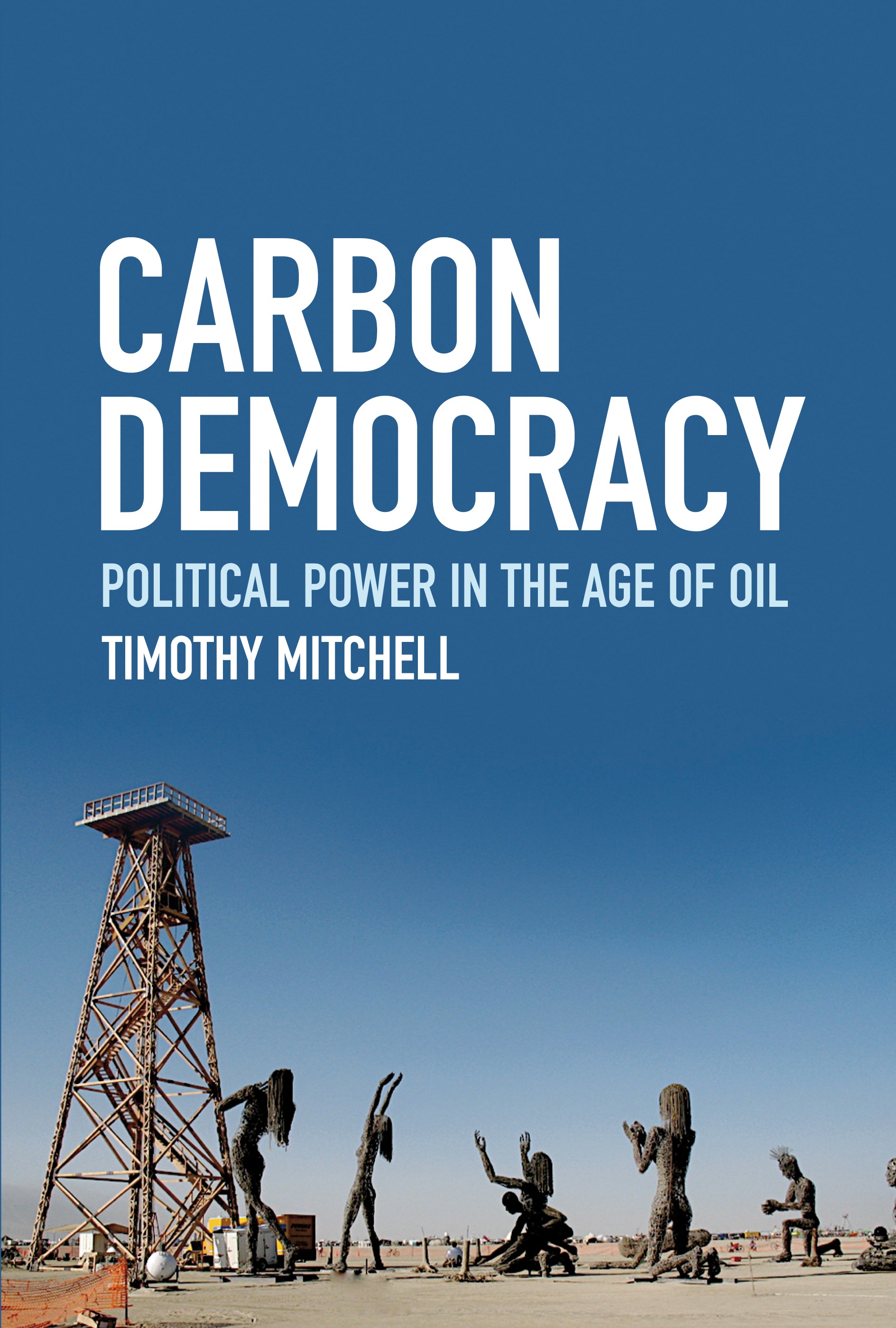
Carbon Democracy Oil is a curse, it is often said, that condemns the countries producing it to an existence defined by war, corruption and enormous inequality. Carbon Democracy tells a more complex story, arguing that no nation escapes the political consequences of our collective dependence on oil. It shapes the body politic both in regions such as the Middle East, which rely upon revenues from oil production, and in the places that have the greatest demand for energy. Timothy Mitchell begins with the history of coal power to tell a radical new story about the rise of democracy. Coal was a source of energy so open to disruption that oligarchies in the West became vulnerable for the first time to mass demands for democracy. In the mid-twentieth century, however, the development of cheap and abundant energy from oil, most notably from the Middle East, offered a means to reduce this vulnerability to democratic pressures. The abundance of oil made it possible for the first time in history to reorganize political life around the management of something now called “the economy” and the promise of its infinite growth. The politics of the West became dependent on an undemocratic Middle East. In the twenty-first century, the oil-based forms of modern democratic politics have become unsustainable. Foreign intervention and military rule are faltering in the Middle East, while governments everywhere appear incapable of addressing the crises that threaten to end the age of carbon democracy—the disappearance of cheap energy and the carbon-fuelled collapse of the ecological order. In making the production of energy the central force shaping the democratic age, Carbon Democracy rethinks the history of energy, the politics of nature, the theory of democracy, and the place of the Middle East in our common world. POLITICAL SCIENCE,Public Policy,Environmental Policy
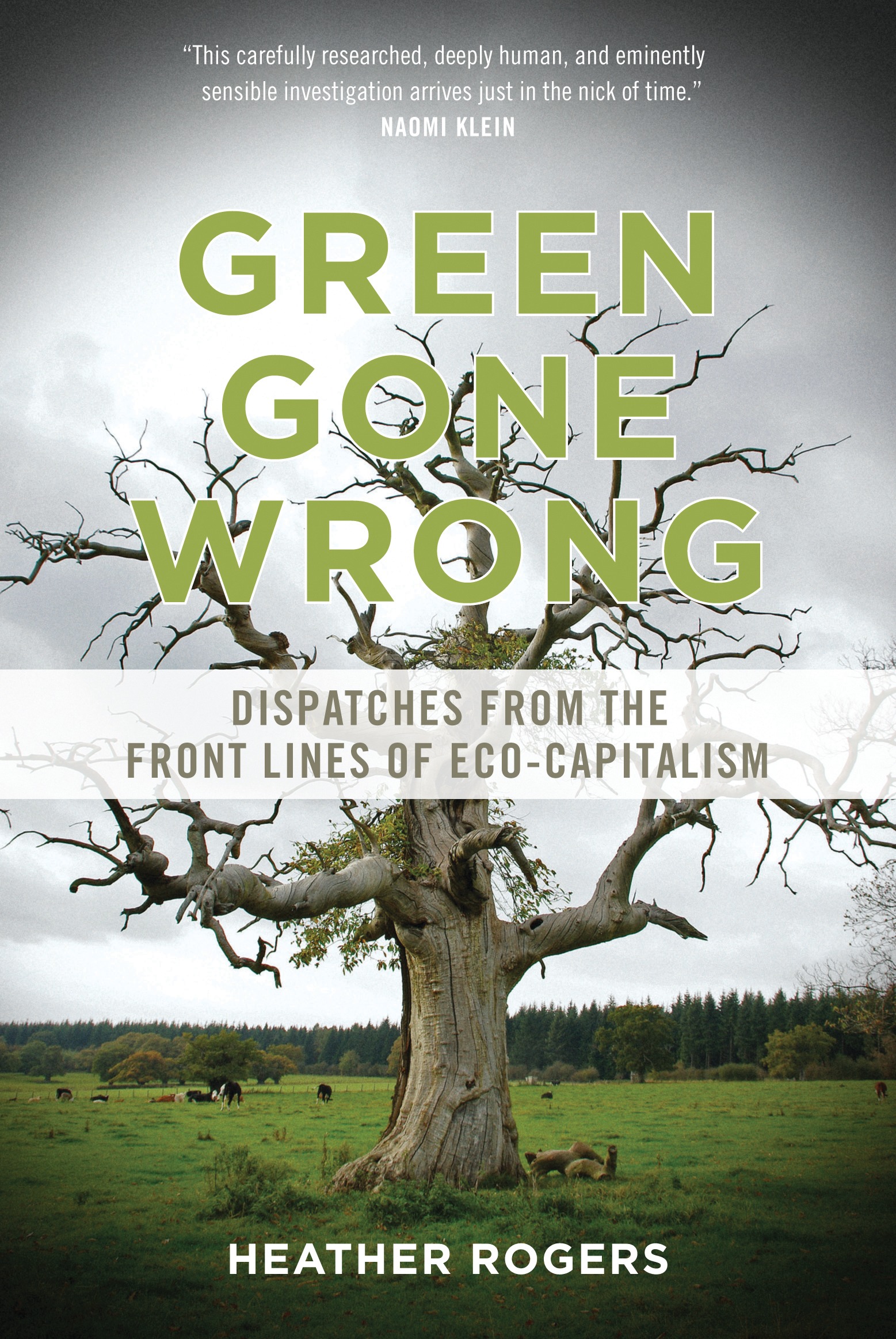
Green Gone Wrong Faced with climate change, many counsel “going green” by buying organic food or a “clean” car. But can we rely on consumerism as a solution to the very problems it has helped cause? Heather Rogers travels from Paraguay to Indonesia, via the Hudson Valley, Detroit and London, to investigate green capitalism, and argues for solutions that are not mere palliatives or distractions, but ways of engaging with how we live and the kind of world we want to live in. POLITICAL SCIENCE,Public Policy,Environmental Policy
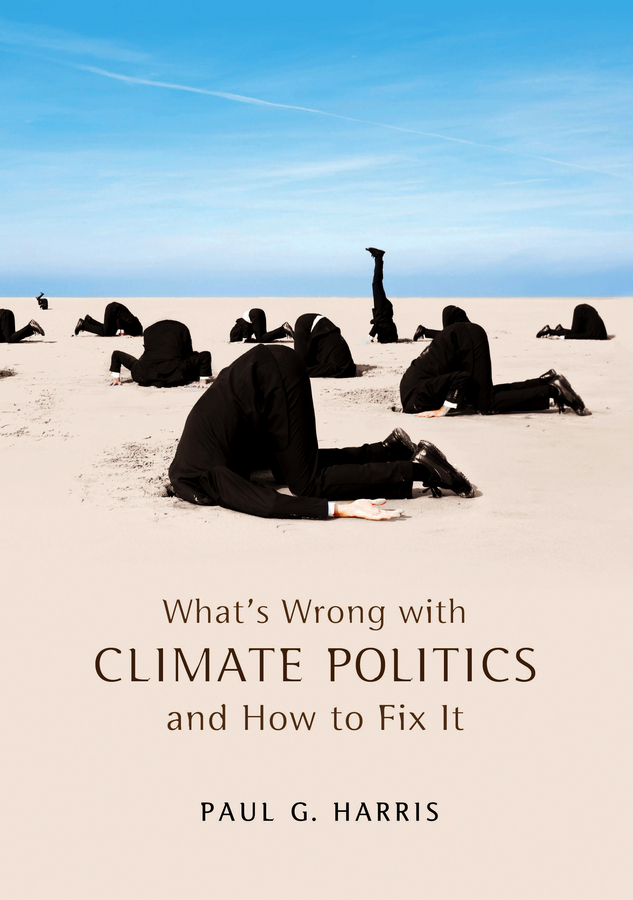
What's Wrong with Climate Politics and How to Fix It Governments have failed to stem global emissions of carbon dioxide and other greenhouse gases causing climate change. Indeed, climate-changing pollution is increasing globally, and will do so for decades to come without far more aggressive action. What explains this failure to effectively tackle one of the world's most serious problems? And what can we do about it? To answer these questions, Paul G. Harris looks at climate politics as a doctor might look at a very sick patient. He performs urgent diagnoses and prescribes vital treatments to revive our ailing planet before it's too late. The book begins by diagnosing what’s most wrong with climate politics, including the anachronistic international system, which encourages nations to fight for their narrowly perceived interests and makes major cuts in greenhouse pollution extraordinarily difficult; the deadlock between the United States and China, which together produce over one-third of global greenhouse gas pollution but do little more than demand that the other act first; and affluent lifestyles and overconsumption, which are spreading rapidly from industrialized nations to the developing world. The book then prescribes several "remedies" for the failed politics of climate change, including a new kind of climate diplomacy with people at its center, national policies that put the common but differentiated responsibilities of individuals alongside those of nations, and a campaign for simultaneously enhancing human wellbeing and environmental sustainability. While these treatments are aspirational, they are not intended to be utopian. As Harris shows, they are genuine, workable solutions to what ails the politics of climate change today. POLITICAL SCIENCE,Public Policy,Environmental Policy
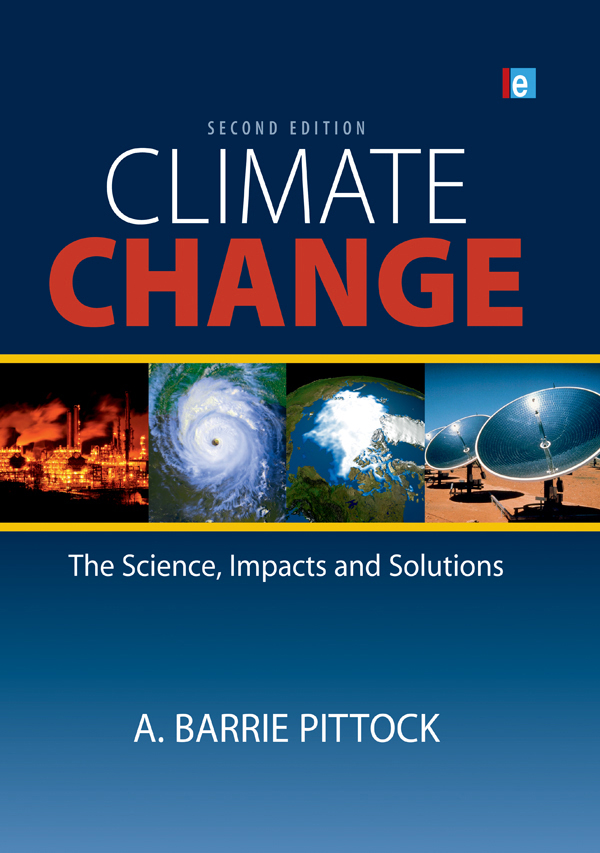
Climate Change It is widely accepted in the scientific community that climate change is a reality, and that changes are happening with increasing rapidity. In this second edition, leading climate researcher Barrie Pittock revisits the effects that global warming is having on our planet, in light of ever-evolving scientific research.Presenting all sides of the arguments about the science and possible remedies, Pittock examines the latest analyses of climate change, such as new and alarming observations regarding Arctic sea ice, the recently published IPCC Fourth Assessment Report, and the policies of the new Australian Government and how they affect the implementation of climate change initiatives.New material focuses on massive investments in large-scale renewables, such as the kind being taken up in California, as well as many smaller-scale activities in individual homes and businesses which are being driven by both regulatory and market mechanisms. The book includes extensive endnotes with links to ongoing and updated information, as well as some new illustrations.While the message is clear that climate change is here (and in some areas, might already be having disastrous effects), there is still hope for the future, and the ideas presented here will inspire people to take action. Climate Change: The Science, Impacts and Solutions is an important reference for students in environmental or social sciences, policy makers, and people who are genuinely concerned about the future of our environment. POLITICAL SCIENCE,Public Policy,Environmental Policy
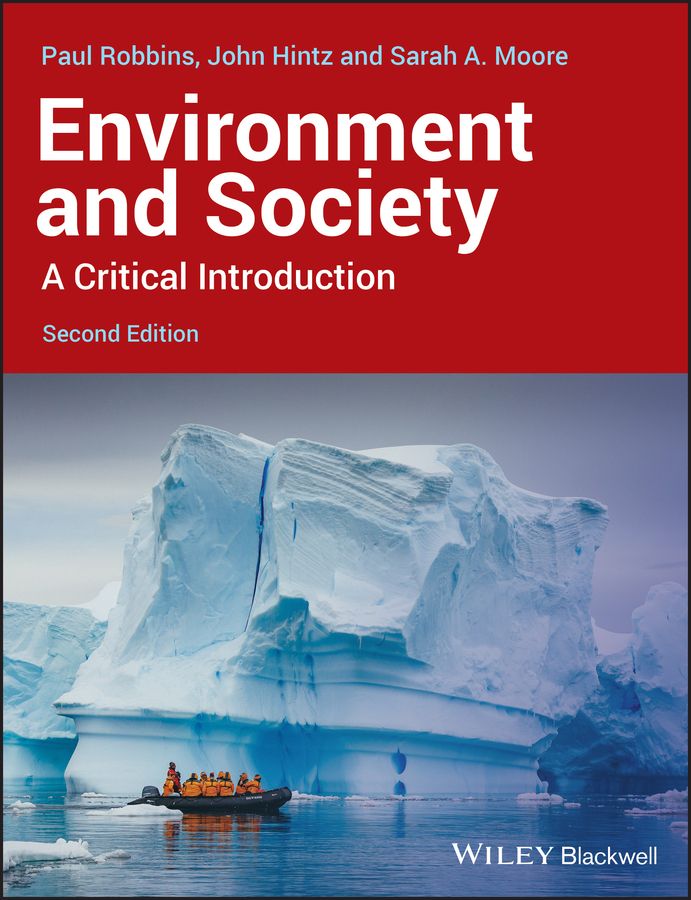
Environment and Society Substantially updated for the second edition, this engaging and innovative introduction to the environment and society uses key theoretical approaches to explore familiar objects. Features substantial revisions and updates for the second edition, including new chapters on E waste, mosquitoes and uranium, improved maps and graphics, new exercises, shorter theory chapters, and refocused sections on environmental solutions Discusses topics such as population and scarcity, commodities, environmental ethics, risks and hazards, and political economy and applies them to objects like bottled water, tuna, and trees Accessible for students, and accompanied by in-book and online resources including exercises and boxed discussions, an online test bank, notes, suggested reading, and website links for enhanced understanding Offers additional online support for instructors, including suggested teaching models, PowerPoint slides for each chapter with full-color graphics, and supplementary images and teaching material POLITICAL SCIENCE,Public Policy,Environmental Policy
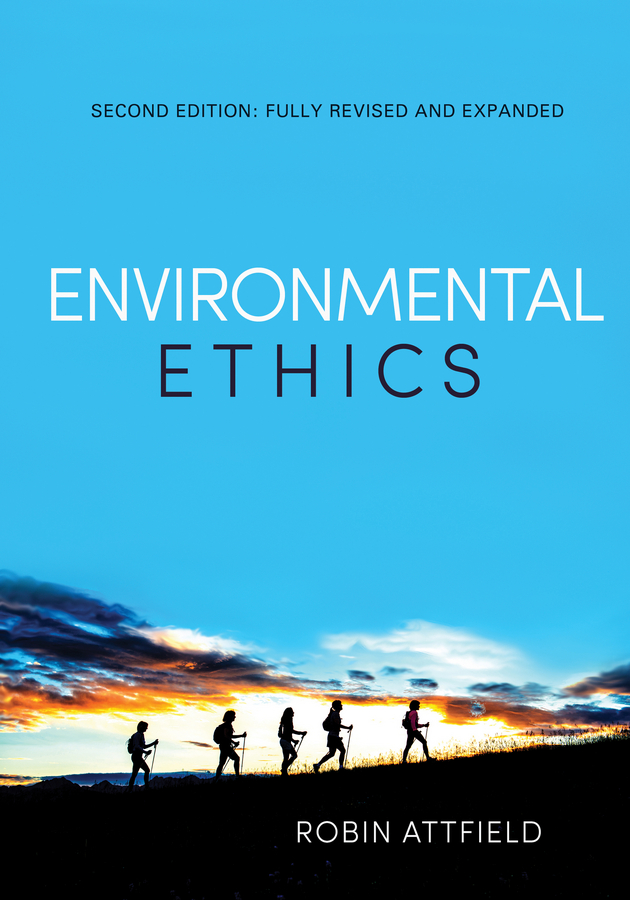
Environmental Ethics In this clear, concise, comprehensively revised and up-to-date introduction to environmental ethics, Robin Attfield guides the student through the key issues and debates in this field in ways that will also be of interest to a wide range of scholars and researchers. The book introduces environmental problems and environmental ethics and surveys theories of the sources of the problems. Attfield also puts forward his own original contribution to the debates, advocating biocentric consequentialism among theories of normative ethics and defending objectivism in meta-ethics. The possibilities of ethical consumerism and investment are discussed, and the nature and basis of responsibilities for future generations in such areas as sustainable development are given detailed consideration. Attfield adopts an inclusive, cosmopolitan perspective in discussions of global ethics and citizenship, and illustrates his argument with a discussion of global warming, mitigation, adaptation and global justice. The revised edition features a new chapter on climate change, new treatments of animal issues, ecofeminism, environmental aesthetics, invasion biology and virtue ethics, and new applications of the precautionary principle to fisheries, genetic engineering and synthetic biology. The glossary and bibliography have been updated to assist understanding of these themes. The text uses a range of devices to aid understanding, such as summaries of key issues, and guides to further reading and relevant websites. It has been written particularly with a view to the needs of students taking courses in environmental ethics, and will be of interest to students and scholars of philosophy, ethics, geography, religion and environmental studies. POLITICAL SCIENCE,Public Policy,Environmental Policy
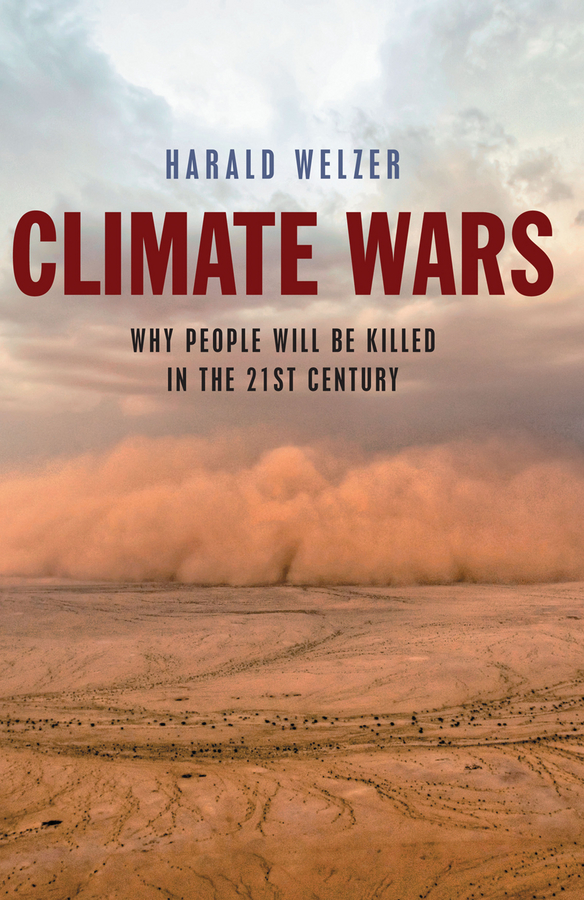
Climate Wars Struggles over drinking water, new outbreaks of mass violence, ethnic cleansing, civil wars in the earth's poorest countries, endless flows of refugees: these are the new conflicts and forces shaping the world of the 21st century. They no longer hinge on ideological rivalries between great powers but rather on issues of class, religion and resources. The genocides of the last century have taught us how quickly social problems can spill over into radical and deadly solutions. Rich countries are already developing strategies to garner resources and keep 'climate refugees' at bay. In this major book Harald Welzer shows how climate change and violence go hand in hand. Climate change has far-reaching consequences for the living conditions of peoples around the world: inhabitable spaces shrink, scarce resources become scarcer, injustices grow deeper, not only between North and South but also between generations, storing up material for new social tensions and giving rise to violent conflicts, civil wars and massive refugee flows. Climate change poses major new challenges in terms of security, responsibility and justice, but as Welzer makes disturbingly clear, very little is being done to confront them. The paperback edition includes a new Preface that brings the book up to date and addresses the most recent developments and trends. POLITICAL SCIENCE,Public Policy,Environmental Policy

What is Environmental History? What is environmental history? It is a kind of history that seeks understanding of human beings as they have lived, worked, and thought in relationship to the rest of nature through the changes brought by time. In this new edition of his seminal student textbook, J. Donald Hughes provides a masterful overview of the thinkers, topics, and perspectives that have come to constitute the exciting discipline that is environmental history. He does so on a global scale, drawing together disparate trends from a rich variety of countries into a unified whole, illuminating trends and key themes in the process. Those already familiar with the discipline will find themselves invited to think about the subject in a new way. This new edition has been updated to reflect recent developments, trends, and new work in environmental history, as well as a brand new note on its possible future. Students and scholars new to environmental history will find the book both an indispensable guide and a rich source of inspiration for future work. POLITICAL SCIENCE,Public Policy,Environmental Policy
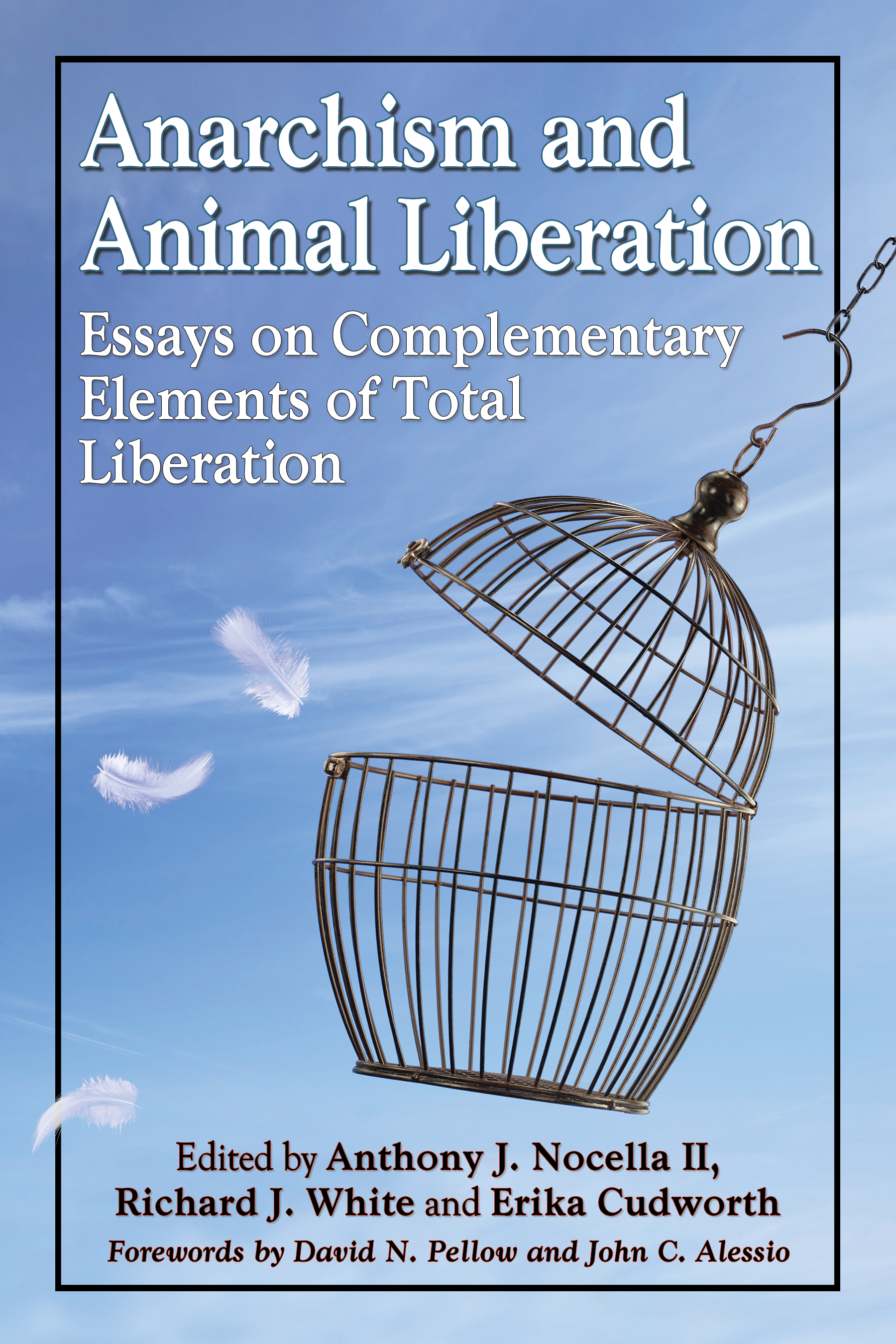
Anarchism and Animal Liberation Building upon anarchist critiques of racism, sexism, ableism and classism, this collection of new essays melds anarchism with animal advocacy in arguing that speciesism is an ideological and social norm rooted in hierarchy and inequality. Rising from the anarchist-influenced Occupy Movement, this book brings together international scholars and activists who challenge us all to look more critically into the causes of speciesism and to take a broader view of peace, social justice and the nature of oppression. Animal advocates have long argued that speciesism will end if the humanity adopts a vegan ethic. This concept is developed into the argument that the vegan ethic has the most promise if it is also anti-capitalist and against all forms of domination. POLITICAL SCIENCE,Public Policy,Environmental Policy

Staying Alive Inspired by women’s struggles for the protection of nature as a condition for human survival, award-winning environmentalist Vandana Shiva shows how ecological destruction and the marginalization of women are not inevitable, economically or scientifically. She argues that “maldevelopment”—the violation of the integrity of organic, interconnected, and interdependent systems that sets in motion a process of exploitation, inequality, and injustice—is dragging the world down a path of self-destruction, threatening survival itself. Shiva articulates how rural Indian women experience and perceive ecological destruction and its causes, and how they have conceived and initiated processes to arrest the destruction of nature and begin its regeneration. Focusing on science and development as patriarchal projects, Staying Alive is a powerfully relevant book that positions women not solely as survivors of the crisis, but as the source of crucial insights and visions to guide our struggle. POLITICAL SCIENCE,Public Policy,Environmental Policy
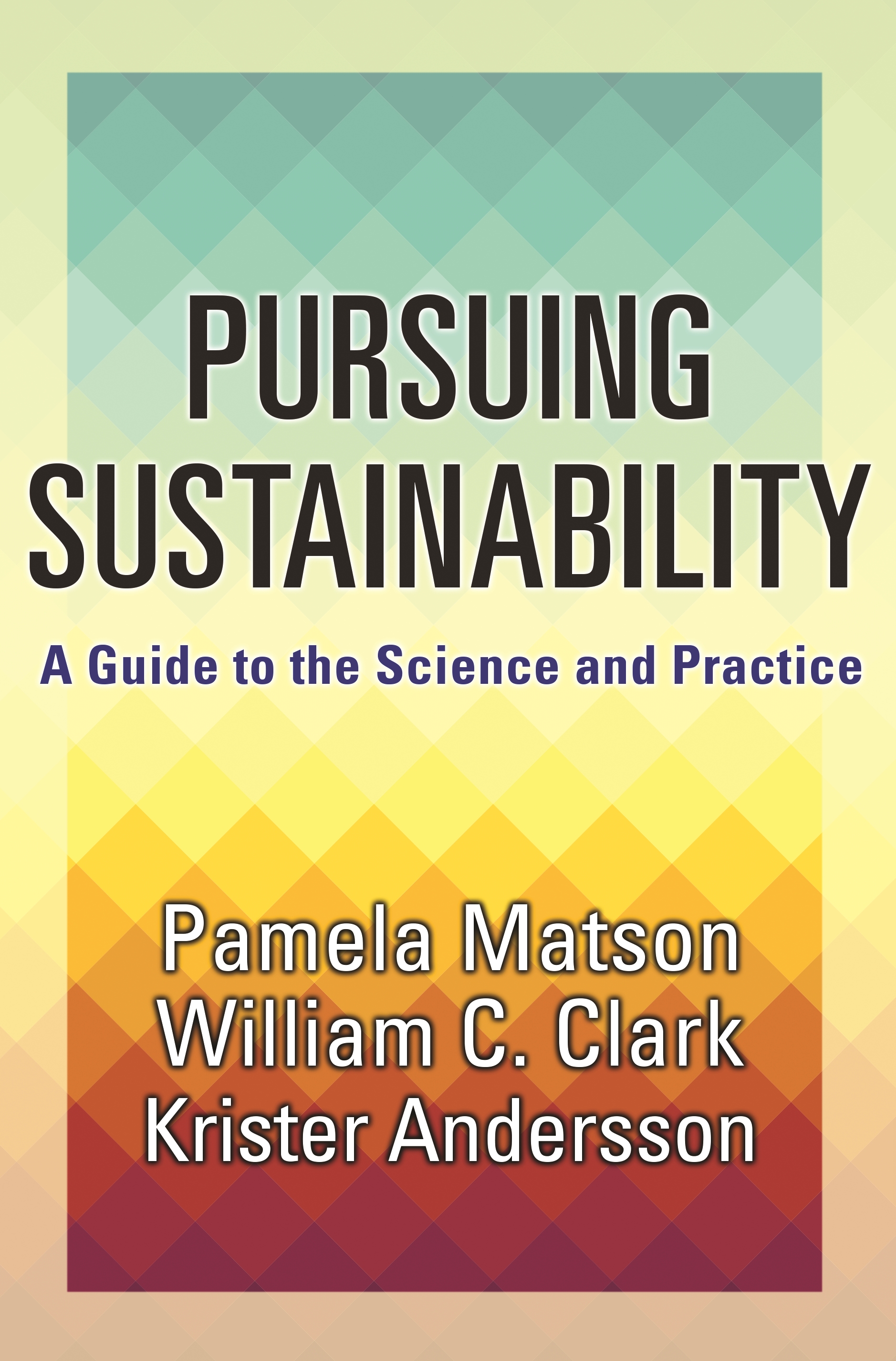
Pursuing Sustainability An essential guide to sustainable development for students and practitioners Sustainability is a global imperative and a scientific challenge like no other. This concise guide provides students and practitioners with a strategic framework for linking knowledge with action in the pursuit of sustainable development, and serves as an invaluable companion to more narrowly focused courses dealing with sustainability in particular sectors such as energy, food, water, and housing, or in particular regions of the world. Written by leading experts, Pursuing Sustainability shows how more inclusive and interdisciplinary approaches and systems perspectives can help you achieve your sustainability objectives. It stresses the need for understanding how capital assets are linked to sustainability goals through the complex adaptive dynamics of social-environmental systems, how committed people can use governance processes to alter those dynamics, and how successful interventions can be shaped through collaborations among researchers and practitioners on the ground. The ideal textbook for undergraduate and graduate students and an invaluable resource for anyone working in this fast-growing field, Pursuing Sustainability also features case studies, a glossary, and suggestions for further reading. Provides a strategic framework for linking knowledge with action Draws on the latest cutting-edge science and practices Serves as the ideal companion text to more narrowly focused courses Utilizes interdisciplinary approaches and systems perspectives Illustrates concepts with a core set of case studies used throughout the book Written by world authorities on sustainability An online illustration package is available to professors POLITICAL SCIENCE,Public Policy,Environmental Policy

Changing Climate Politics Changing Climate Politics provides a comprehensive account of the current state of government action and political participation in the United States on the issue of climate change. Author Yael Wolinsky-Nahmias evaluates the role of the federal government, the courts, states, and cities in tackling the problems created by climate change, offering an inclusive and balanced assessment of progress and challenges. The book further explores the growing role of civic society in climate action plans, analyzing public opinion, the U.S. climate movement, policy making through ballot measures, consumer action, and the prospect of a social transformation toward a more sustainable society. This timely volume examines new approaches to policies and civic action on climate change addressing critical questions about the responsibilities and obligations of governments and citizens. POLITICAL SCIENCE,Public Policy,Environmental Policy
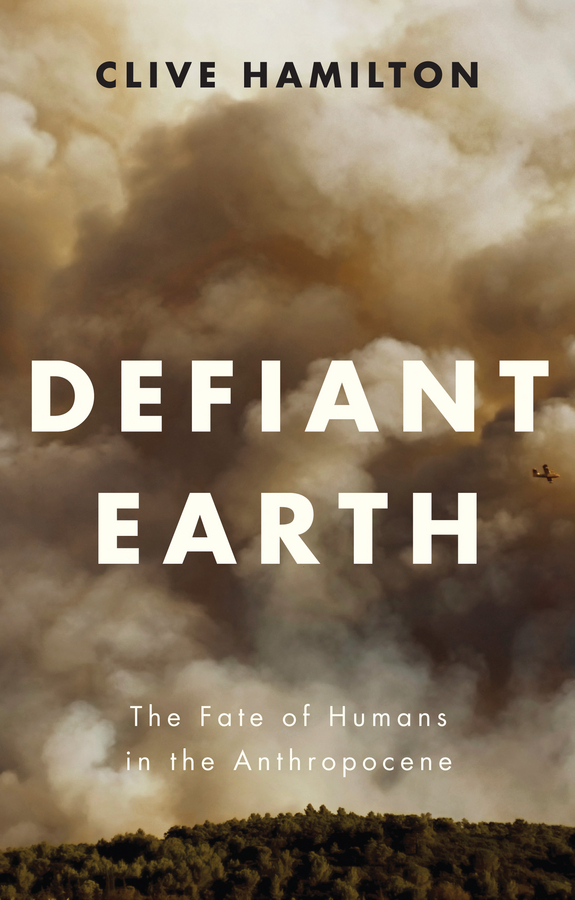
Defiant Earth Humans have become so powerful that we have disrupted the functioning of the Earth System as a whole, bringing on a new geological epoch – the Anthropocene – one in which the serene and clement conditions that allowed civilisation to flourish are disappearing and we quail before 'the wakened giant'. The emergence of a conscious creature capable of using technology to bring about a rupture in the Earth's geochronology is an event of monumental significance, on a par with the arrival of civilisation itself. What does it mean to have arrived at this point, where human history and Earth history collide? Some interpret the Anthropocene as no more than a development of what they already know, obscuring and deflating its profound significance. But the Anthropocene demands that we rethink everything. The modern belief in the free, reflexive being making its own future by taking control of its environment – even to the point of geoengineering – is now impossible because we have rendered the Earth more unpredictable and less controllable, a disobedient planet. At the same time, all attempts by progressives to cut humans down to size by attacking anthropocentrism come up against the insurmountable fact that human beings now possess enough power to change the Earth's course. It's too late to turn back the geological clock, and there is no going back to premodern ways of thinking. We must face the fact that humans are at the centre of the world, even if we must give the idea that we can control the planet. These truths call for a new kind of anthropocentrism, a philosophy by which we might use our power responsibly and find a way to live on a defiant Earth. POLITICAL SCIENCE,Public Policy,Environmental Policy
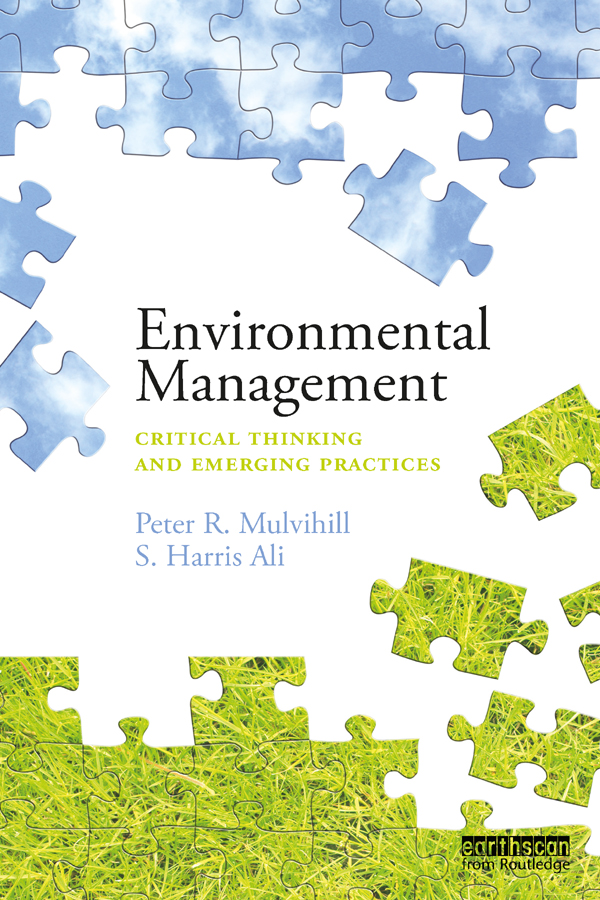
Environmental Management The field of Environmental Management (EM) involves a broad and evolving repertoire of practices. The field originated around 1970 in response to new policy, regulation and public concern about environmental issues. EM has undergone many changes and improvements since then, progressing from a reactive, compliance-based focus toward, in leading cases, practices reflecting strong commitment to sustainability. And yet, EM remains, for the most part, ill-equipped to deal with the complex and highly uncertain implications of the ecological crisis. Environmental Management offers a rigorous critique of conventional EM and explores alternative ideas, frameworks and approaches that are currently considered "fringe", but which have the potential to transform the practice of EM. This book goes beyond narrow definitions and considers questions regarding the purpose, roles, scope and potential of environmental management. EM is situated and contextualized within the evolving and expanding realm of environment and sustainability literature. The book argues that new approaches to EM need to be more flexible, imaginative and better equipped to address future environmental problems of a scale and severity previously unforeseen. This book will be of great interest to students and scholars of environmental management, environmental planning, resource management, and environmental assessment. POLITICAL SCIENCE,Public Policy,Environmental Policy

This Land Is Our Land Private property is everywhere. Almost anywhere you walk in the United States, you will spot “No Trespassing” and “Private Property” signs on trees and fence posts. In America, there are more than a billion acres of grassland pasture, cropland, and forest, and miles and miles of coastlines that are mostly closed off to the public. Meanwhile, America’s public lands are threatened by extremist groups and right-wing think tanks who call for our public lands to be sold to the highest bidder and closed off to everyone else. If these groups get their way, public property may become private, precious green spaces may be developed, and the common good may be sacrificed for the benefit of the wealthy few. Ken Ilgunas, lifelong traveler, hitchhiker, and roamer, takes readers back to the nineteenth century, when Americans were allowed to journey undisturbed across the country. Today, though, America finds itself as an outlier in the Western world as a number of European countries have created sophisticated legal systems that protect landowners and give citizens generous roaming rights to their countries' green spaces. Inspired by the United States' history of roaming, and taking guidance from present-day Europe, Ilgunas calls into question our entrenched understanding of private property and provocatively proposes something unheard of: opening up American private property for public recreation. He imagines a future in which folks everywhere will have the right to walk safely, explore freely, and roam boldly—from California to the New York island, from the Redwood Forest to the Gulf Stream waters. POLITICAL SCIENCE,Public Policy,Environmental Policy
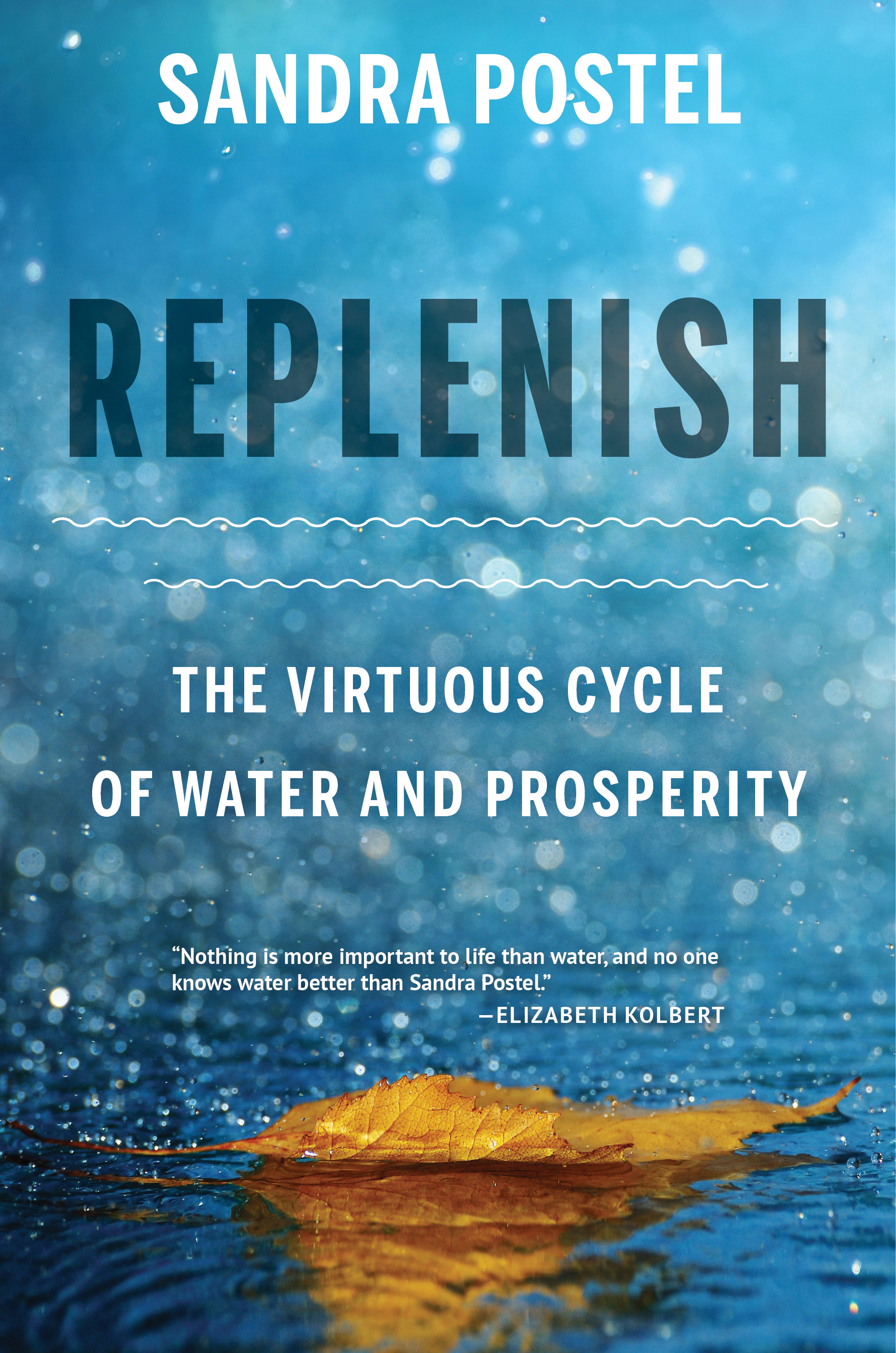
Replenish We have disrupted the natural water cycle for centuries in an effort to control water for our own prosperity. Yet every year, recovery from droughts and floods costs billions of dollars, and we spend billions more on dams, diversions, levees, and other feats of engineering.These massive projects not only are risky financially and environmentally, they often threaten social and political stability. What if the answer was not further control of the water cycle, but repair and replenishment? Sandra Postel takes readers around the world to explore water projects that work with, rather than against, nature'srhythms. In New Mexico, forest rehabilitation is safeguarding drinking water; along the Mississippi River, farmers are planting cover crops toreduce polluted runoff; and in China, "sponge cities†are capturing rainwater to curb urban flooding. Efforts like these will be essential as climate change disrupts both weather patterns and the models on which we base our infrastructure. We will be forced to adapt. The question is whether we will continue to fight the water cycle or recognize our place in it and take advantage of the inherservices nature offers. Water, Postel writes, is a gift,the source of life itself. How will we use this greatest of gifts? POLITICAL SCIENCE,Public Policy,Environmental Policy

The Poisoned City When the people of Flint, Michigan, turned on their faucets in April 2014, the water pouring out was poisoned with lead and other toxins. Through a series of disastrous decisions, the state government had switched the city’s water supply to a source that corroded Flint’s aging lead pipes. Complaints about the foul-smelling water were dismissed: the residents of Flint, mostly poor and African American, were not seen as credible, even in matters of their own lives. It took eighteen months of activism by city residents and a band of dogged outsiders to force the state to admit that the water was poisonous. By that time, twelve people had died and Flint’s children had suffered irreparable harm. The long battle for accountability and a humane response to this man-made disaster has only just begun. In the first full account of this American tragedy, Anna Clark's The Poisoned City recounts the gripping story of Flint’s poisoned water through the people who caused it, suffered from it, and exposed it. It is a chronicle of one town, but could also be about any American city, all made precarious by the neglect of infrastructure and the erosion of democratic decision making. Places like Flint are set up to fail—and for the people who live and work in them, the consequences can be fatal. POLITICAL SCIENCE,Public Policy,Environmental Policy
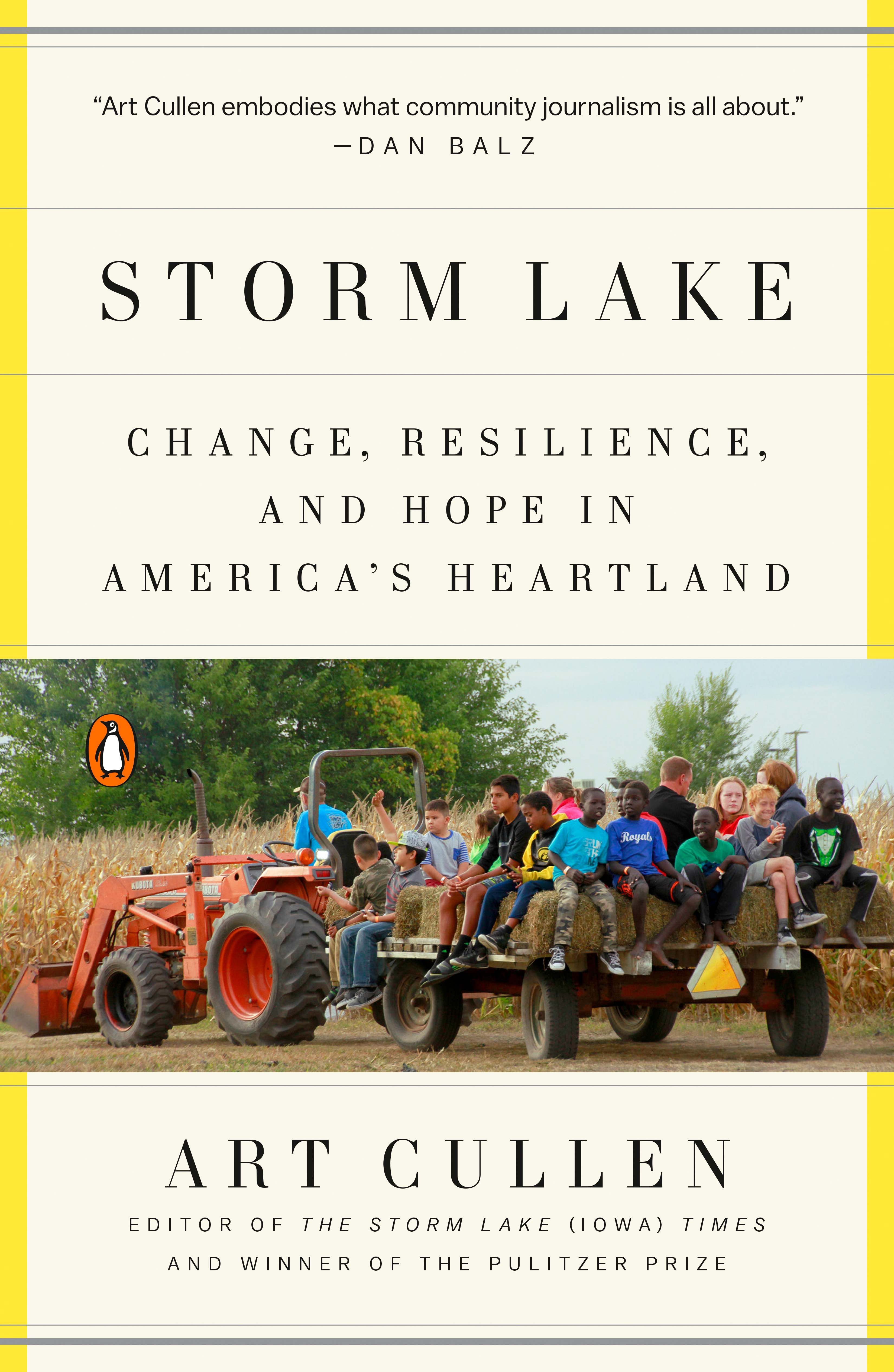
Storm Lake "A reminder that even the smallest newspapers can hold the most powerful among us accountable."—The New York Times Book Review Iowa plays an outsize role in national politics. Iowa introduced Barack Obama and voted bigly for Donald Trump. But is it a bellwether for America, a harbinger of its future? Art Cullen’s answer is complicated and honest. In truth, Iowa is losing ground. The Trump trade wars are hammering farmers and manufacturers. Health insurance premiums and drug prices are soaring. That’s what Iowans are dealing with, and the problems they face are the problems of the heartland. In this candid and timely book, Art Cullen—the Storm Lake Times newspaperman who won a Pulitzer Prize for taking on big corporate agri-industry and its poisoning of local rivers—describes how the heartland has changed dramatically over his career. In a story where politics, agriculture, the environment, and immigration all converge, Cullen offers an unsentimental ode to rural America and to the resilient people of a vibrant community of fifteen thousand in Northwest Iowa, as much survivors as their town. POLITICAL SCIENCE,Public Policy,Environmental Policy
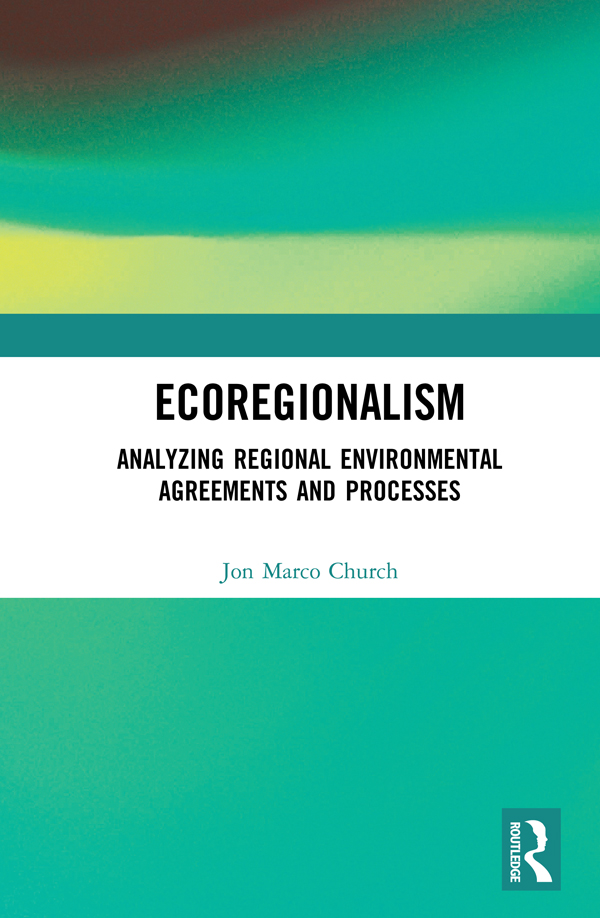
Ecoregionalism This book provides a comprehensive understanding of environmental regionalism at the international level, analyzing the concept and identifying recurring patterns from six in-depth case studies. While ecoregions or environmental regions are defined on ecological boundaries rather than administrative criteria, ecoregionalism is the idea that regional dynamics should cluster around ecoregions, while ecoregionalization is the tendency of regional dynamics to cluster around ecoregions. Focusing on the international level, this book presents six cases of ecoregional processes from around the world and the regional environmental agreements: two are terrestrial, the Alps and the Andes; two are marine, the Mediterranean Sea and the Baltic Sea; two are related to freshwater ecosystems: the Amu Darya in Central Asia and the Great Lakes in North America. The book analyzes both ecoregional processes focused on the environment, as well as intersectoral ecoregional processes. The case studies are analyzed based on the ecoregional governance framework, developed by the author for this book. Despite the diversity of context, the similarity of the governance system of the six cases is striking. Several recurring patterns have been identified, which may also extend to the subnational level. They are not design principles, but may be taken into consideration for the design or redesign of current and future regional environmental agreements and processes. This book will be of great interest to students and scholars of environmental politics, natural resource management, spatial planning and international relations. POLITICAL SCIENCE,Public Policy,Environmental Policy
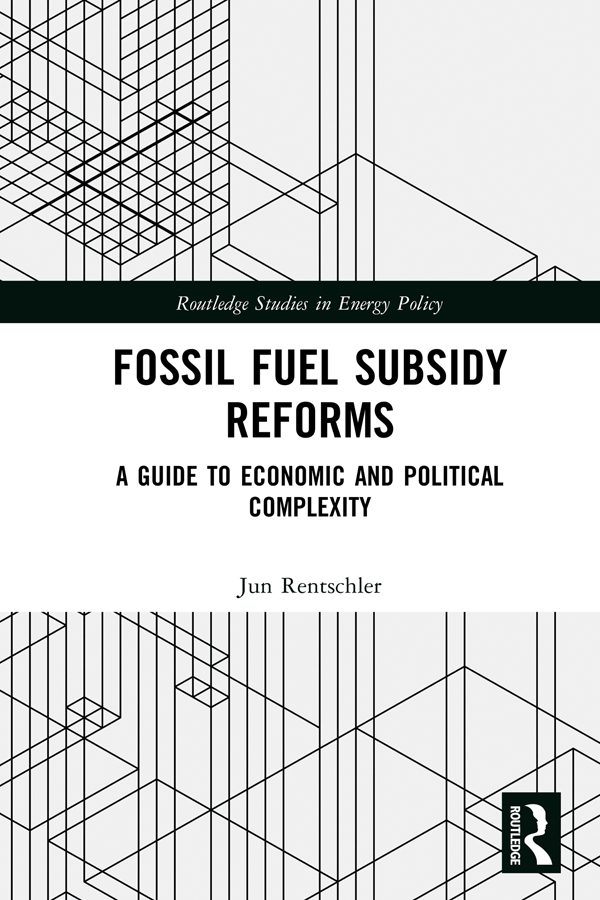
Fossil Fuel Subsidy Reforms Countries around the world are spending up to $500 billion per year on subsidising fossil fuel consumption. By some estimates, the G20 countries alone are spending around another $450 billion on subsidising fossil fuel production. In addition, the indirect social welfare costs of these subsidies have been shown to be substantial – for instance due to air pollution, road congestion, climate change, and economic inefficiency, to name a few. Considering these numbers, there is no doubt that fossil fuel subsidies cause severe economic distortions that compromise countries’ prospects of achieving equitable and sustainable development. This book provides a guide to the complex challenge of designing, assessing, and implementing effective fossil fuel subsidy reforms. It shows that subsidy reform requires a careful balancing of complex economic and political trade-offs, as well as measures to mitigate adverse effects on vulnerable households and to assist firms with implementing efficiency enhancing measures. Going beyond the purely fiscal perspective, this book emphasises that smart subsidy reforms can contribute to all three dimensions of sustainable development – environment, society, and economy. Over the course of eight chapters, this book considers a wide range of agents and stakeholders, markets, and policy measures in order to distil the key principles of designing effective fossil fuel subsidy reforms. This book will be of great relevance to scholars and policy makers with an interest in energy economics and policy, climate change policy, and sustainable development more broadly. POLITICAL SCIENCE,Public Policy,Environmental Policy
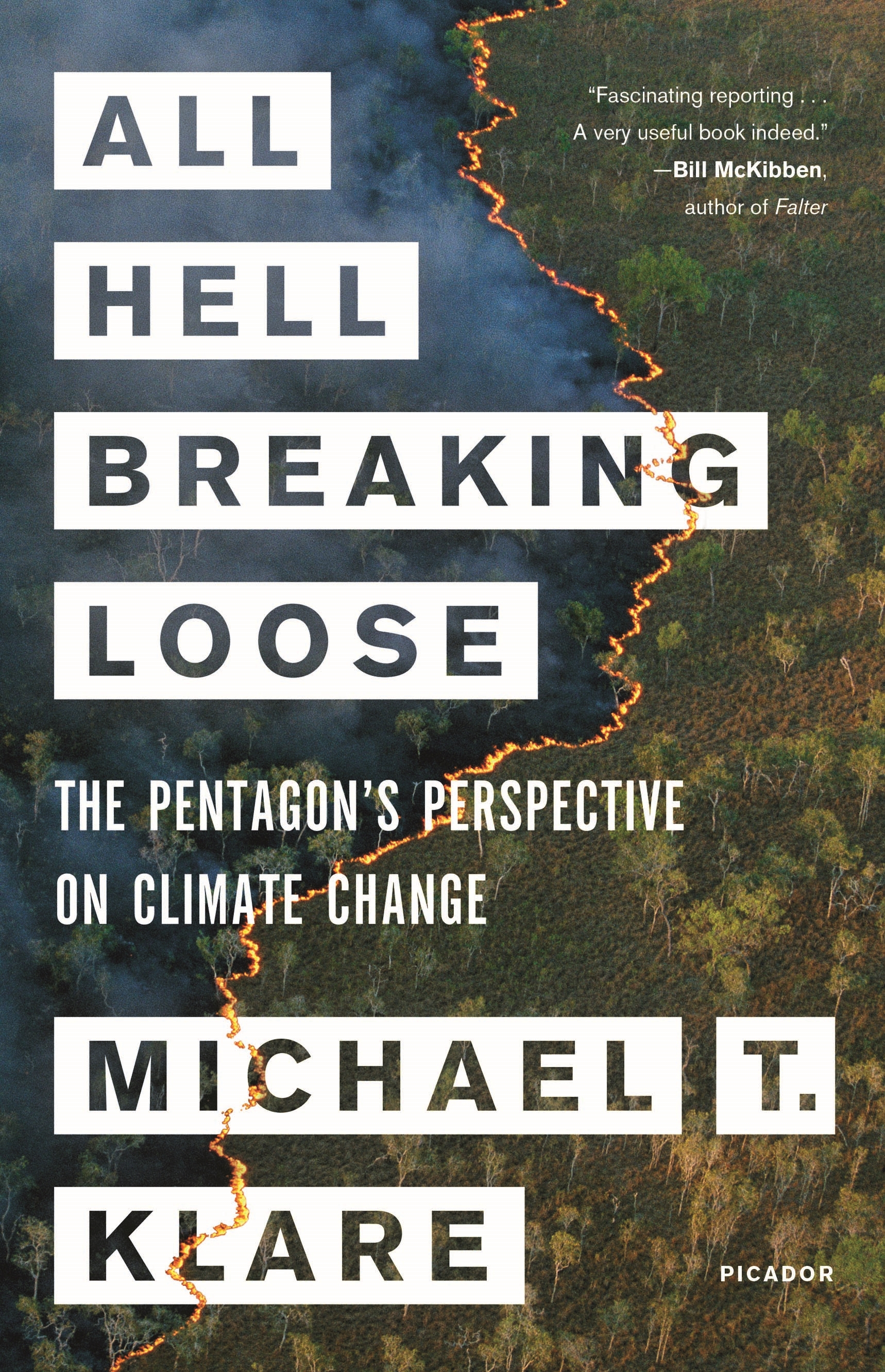
All Hell Breaking Loose All Hell Breaking Loose is an eye-opening examination of climate change from the perspective of the U.S. military. The Pentagon, unsentimental and politically conservative, might not seem likely to be worried about climate change—still linked, for many people, with polar bears and coral reefs. Yet of all the major institutions in American society, none take climate change as seriously as the U.S. military. Both as participants in climate-triggered conflicts abroad, and as first responders to hurricanes and other disasters on American soil, the armed services are already confronting the impacts of global warming. The military now regards climate change as one of the top threats to American national security—and is busy developing strategies to cope with it. Drawing on previously obscure reports and government documents, renowned security expert Michael Klare shows that the U.S. military sees the climate threat as imperiling the country on several fronts at once. Droughts and food shortages are stoking conflicts in ethnically divided nations, with “climate refugees†producing worldwide havoc. Pandemics and other humanitarian disasters will increasingly require extensive military involvement. The melting Arctic is creating new seaways to defend. And rising seas threaten American cities and military bases themselves. While others still debate the causes of global warming, the Pentagon is intensely focused on its effects. Its response makes it clear that where it counts, the immense impact of climate change is not in doubt. POLITICAL SCIENCE,Public Policy,Environmental Policy
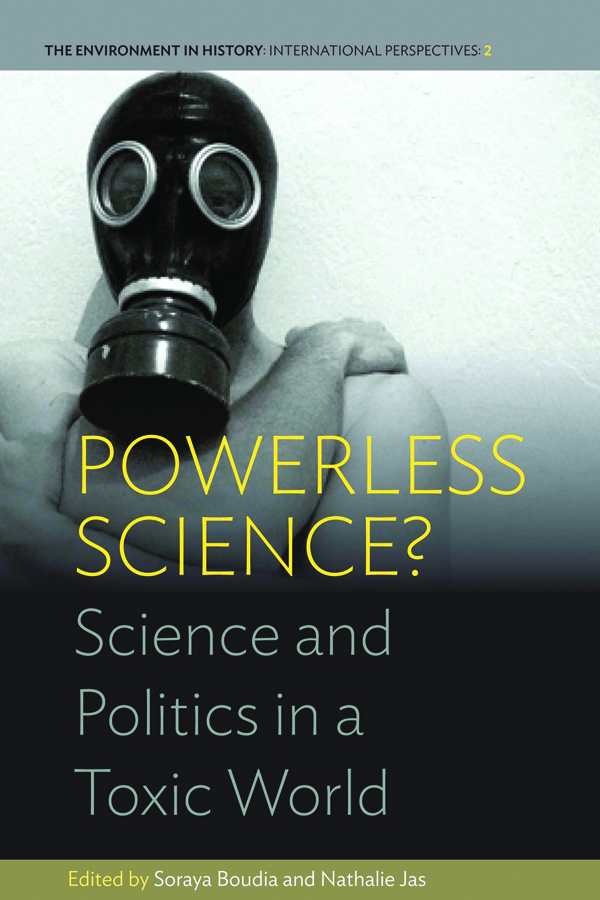
Powerless Science? In spite of decades of research on toxicants, along with the growing role of scientific expertise in public policy and the unprecedented rise in the number of national and international institutions dealing with environmental health issues, problems surrounding contaminants and their effects on health have never appeared so important, sometimes to the point of appearing insurmountable. This calls for a reconsideration of the roles of scientific knowledge and expertise in the definition and management of toxic issues, which this book seeks to do. It looks at complex historical, social, and political dynamics, made up of public controversies, environmental and health crises, economic interests, and political responses, and demonstrates how and to what extent scientific knowledge about toxicants has been caught between scientific, economic, and political imperatives. POLITICAL SCIENCE,Public Policy,Environmental Policy
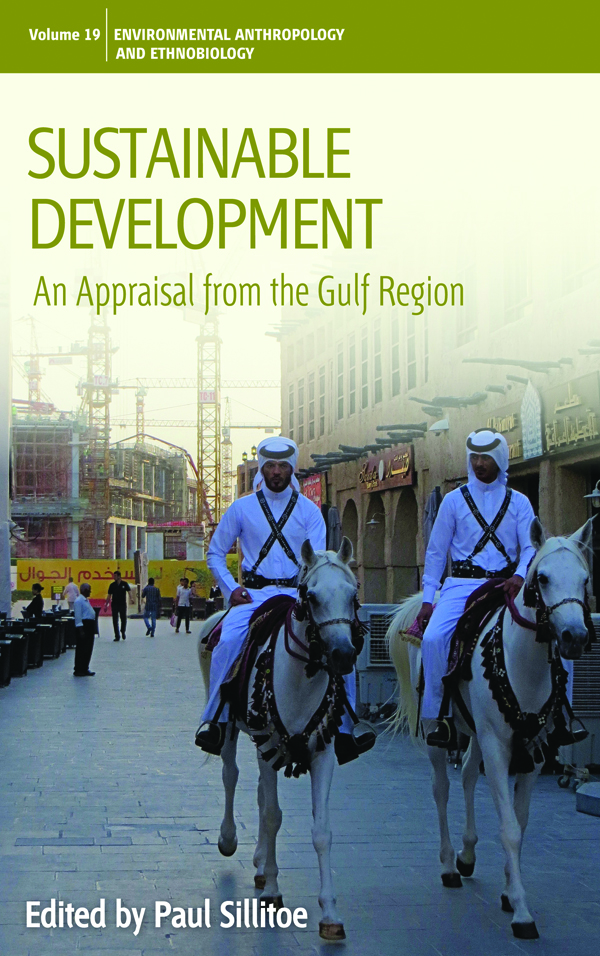
Sustainable Development With growing evidence of unsustainable use of the world’s resources, such as hydrocarbon reserves, and related environmental pollution, as in alarming climate change predictions, sustainable development is arguably the prominent issue of the 21st century. This volume gives a wide ranging introduction focusing on the arid Gulf region, where the challenges of sustainable development are starkly evident. The Gulf relies on non-renewable oil and gas exports to supply the world’s insatiable CO2 emitting energy demands, and has built unsustainable conurbations with water supplies dependent on energy hungry desalination plants and deep aquifers pumped beyond natural replenishment rates. Sustainable Development has an interdisciplinary focus, bringing together university faculty and government personnel from the Gulf, Europe, and North America -- including social and natural scientists, environmentalists and economists, architects and planners -- to discuss topics such as sustainable natural resource use and urbanization, industrial and technological development, economy and politics, history and geography. POLITICAL SCIENCE,Public Policy,Environmental Policy
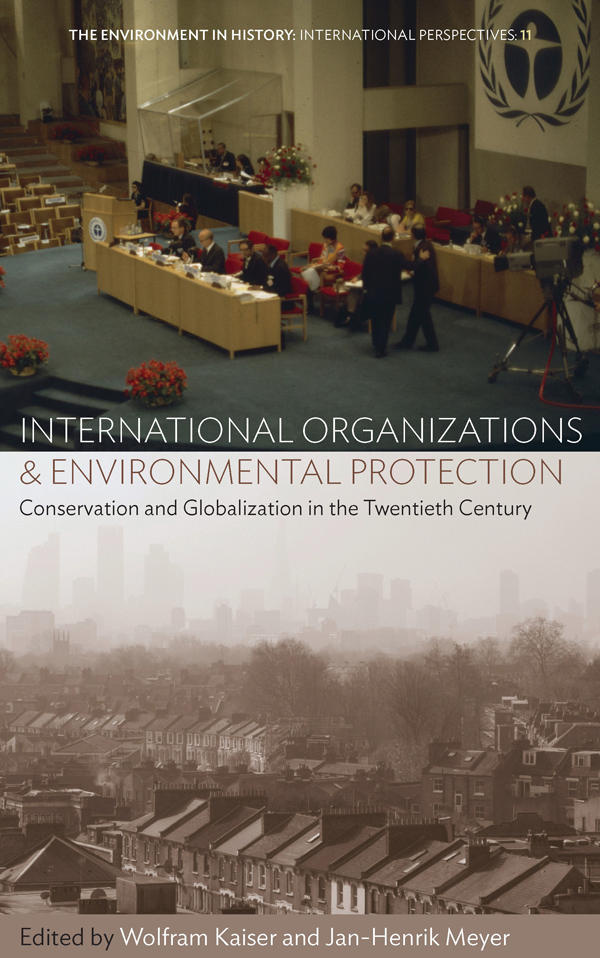
International Organizations and Environmental Protection Pollution, resource depletion, habitat management, and climate change are all issues that necessarily transcend national boundaries. Accordingly, they and other environmental concerns have been a particular focus for international organizations from before the First World War to the present day. This volume is the first to comprehensively explore the environmental activities of professional communities, NGOs, regional bodies, the United Nations, and other international organizations during the twentieth century. It follows their efforts to shape debates about environmental degradation, develop binding intergovernmental commitments, and—following the seminal 1972 Conference on the Human Environment—implement and enforce actual international policies. POLITICAL SCIENCE,Public Policy,Environmental Policy
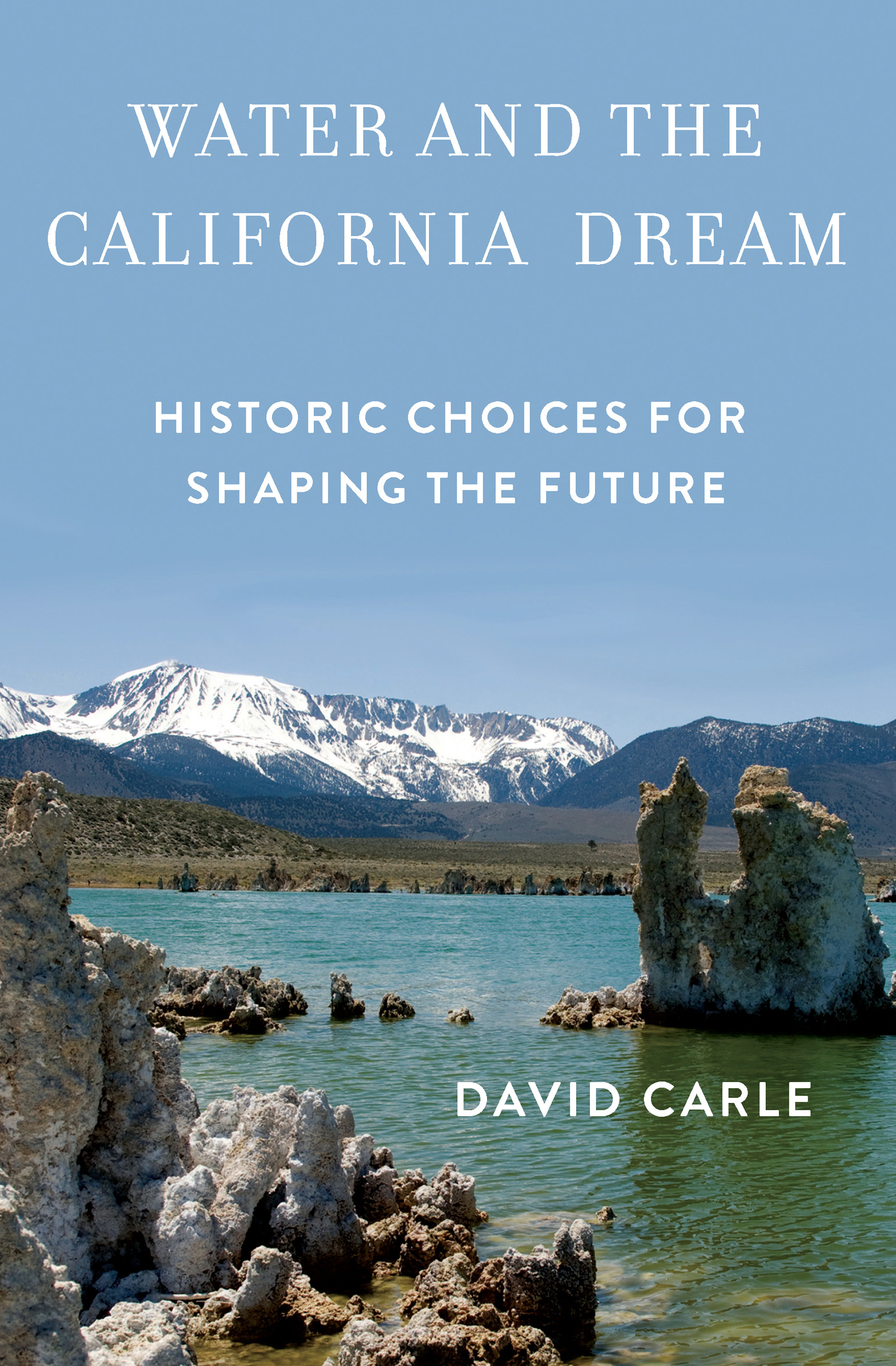
Water and the California Dream “Masterfully researching his subject,†historian David Carle contemplates the future of water conservation in the drought-challenged state of California (Los Angeles Times). Imported water has transformed the Golden State’s environment and quality of life. Land ownership patterns and real estate boosterism dramatically altered both urban and rural communities across the entire state. Using first-person voices of Californians to reveal the resulting changes, Carle concludes that now is the time to stop drowning the California Dream. With extensive use of oral histories, contemporary newspaper articles and autobiographies, Carle provides a rich exploration of the historic changes in California, as imported water shaped patterns of growth and development. In this thoroughly revised edition, Carle brings that history up to date, as water choices remain the primary tool for shaping California’s future. In a land where climate change is exacerbating the challenges of a naturally dry region, the state’s damaged environment and reduced quality of life can be corrected, Carle argues, if Californians step out of the historic pattern and embrace limited water supplies as a fact of life. “California . . . has been involved in some of the most noxious water wars imaginable . . . these down-and-dirty fights receive a fascinating airing.†—San Diego Union Tribune “Inventive and informative text . . . [California’s] infatuation with limitless growth . . . may create a world too ugly to contemplate.†—T. H. Watkins, Wallace Stegner Professor of Western American Studies, Montana State University “Offers a high moral and technological challenge, together with a desperate (and perhaps final!) hope.†—Dr. Kevin Starr, State Librarian of California POLITICAL SCIENCE,Public Policy,Environmental Policy

Last Days of the Mighty Mekong A vivid account of how one of the most remote and naturally beautiful areas in the world is being wholly transformed by rapid industrial and urban development, the scale of which has never been seen before. POLITICAL SCIENCE,Public Policy,Environmental Policy
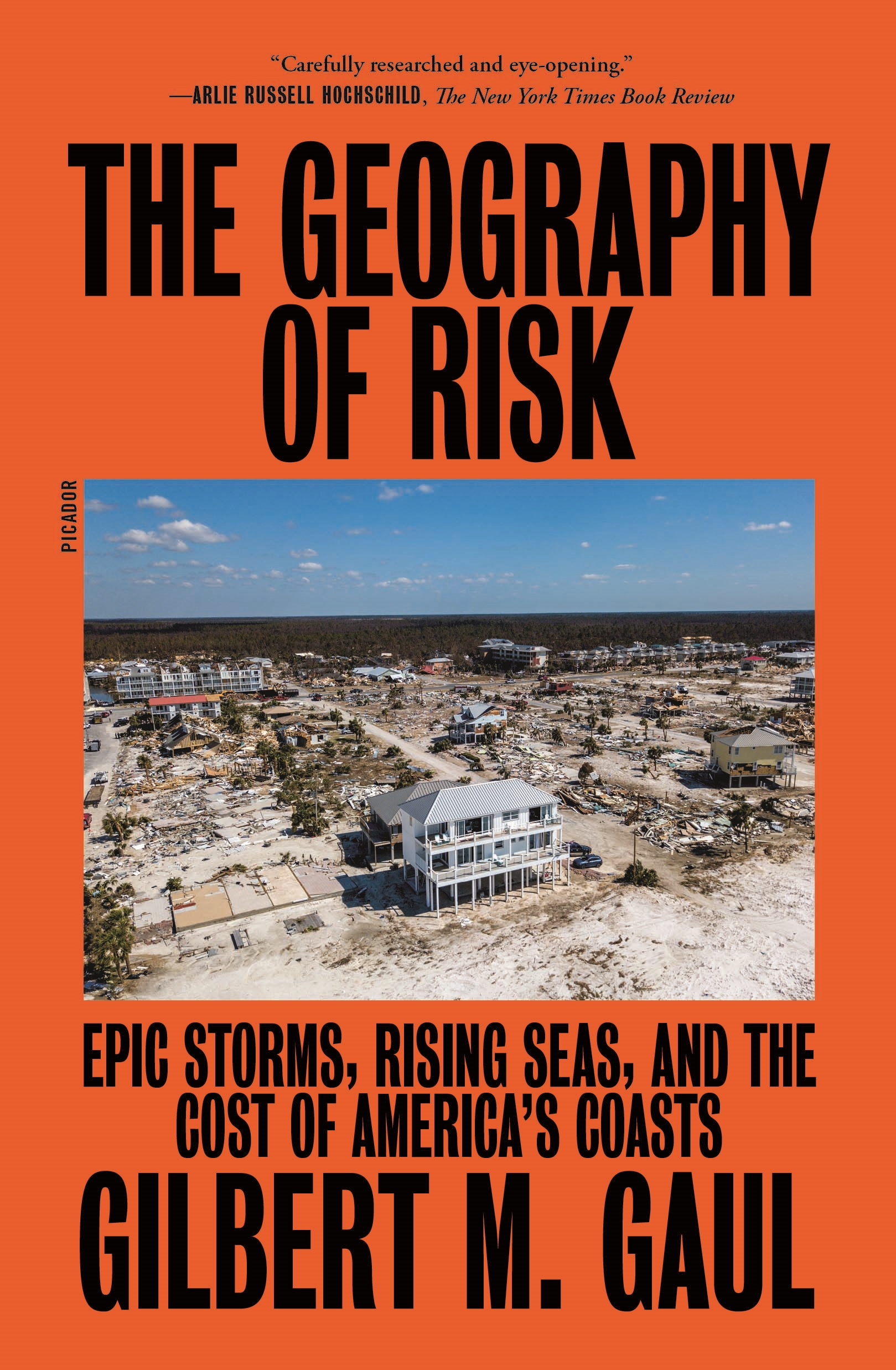
The Geography of Risk This century has seen the costliest hurricanes in U.S. history—but who bears the brunt of these monster storms? Consider this: Five of the most expensive hurricanes in history have made landfall since 2005: Katrina ($160 billion), Ike ($40 billion), Sandy ($72 billion), Harvey ($125 billion), and Maria ($90 billion). With more property than ever in harm’s way, and the planet and oceans warming dangerously, it won’t be long before we see a $250 billion hurricane. Why? Because Americans have built $3 trillion worth of property in some of the riskiest places on earth: barrier islands and coastal floodplains. And they have been encouraged to do so by what Gilbert M. Gaul reveals in The Geography of Risk to be a confounding array of federal subsidies, tax breaks, low-interest loans, grants, and government flood insurance that shift the risk of life at the beach from private investors to public taxpayers, radically distorting common notions of risk. These federal incentives, Gaul argues, have resulted in one of the worst planning failures in American history, and the costs to taxpayers are reaching unsustainable levels. We have become responsible for a shocking array of coastal amenities: new roads, bridges, buildings, streetlights, tennis courts, marinas, gazebos, and even spoiled food after hurricanes. The Geography of Risk will forever change the way you think about the coasts, from the clash between economic interests and nature, to the heated politics of regulators and developers. POLITICAL SCIENCE,Public Policy,Environmental Policy

Smart Villages in the EU and Beyond Increasing depopulation is causing huge problems for rural communities, leading to a reduction in services and infrastructure in areas with ageing populations. This book examines the concept of the Smart Village, an ICT-conscious integrated strategy which provides a sustainable solution to these problems, helping to revitalize rural areas. POLITICAL SCIENCE,Public Policy,Environmental Policy
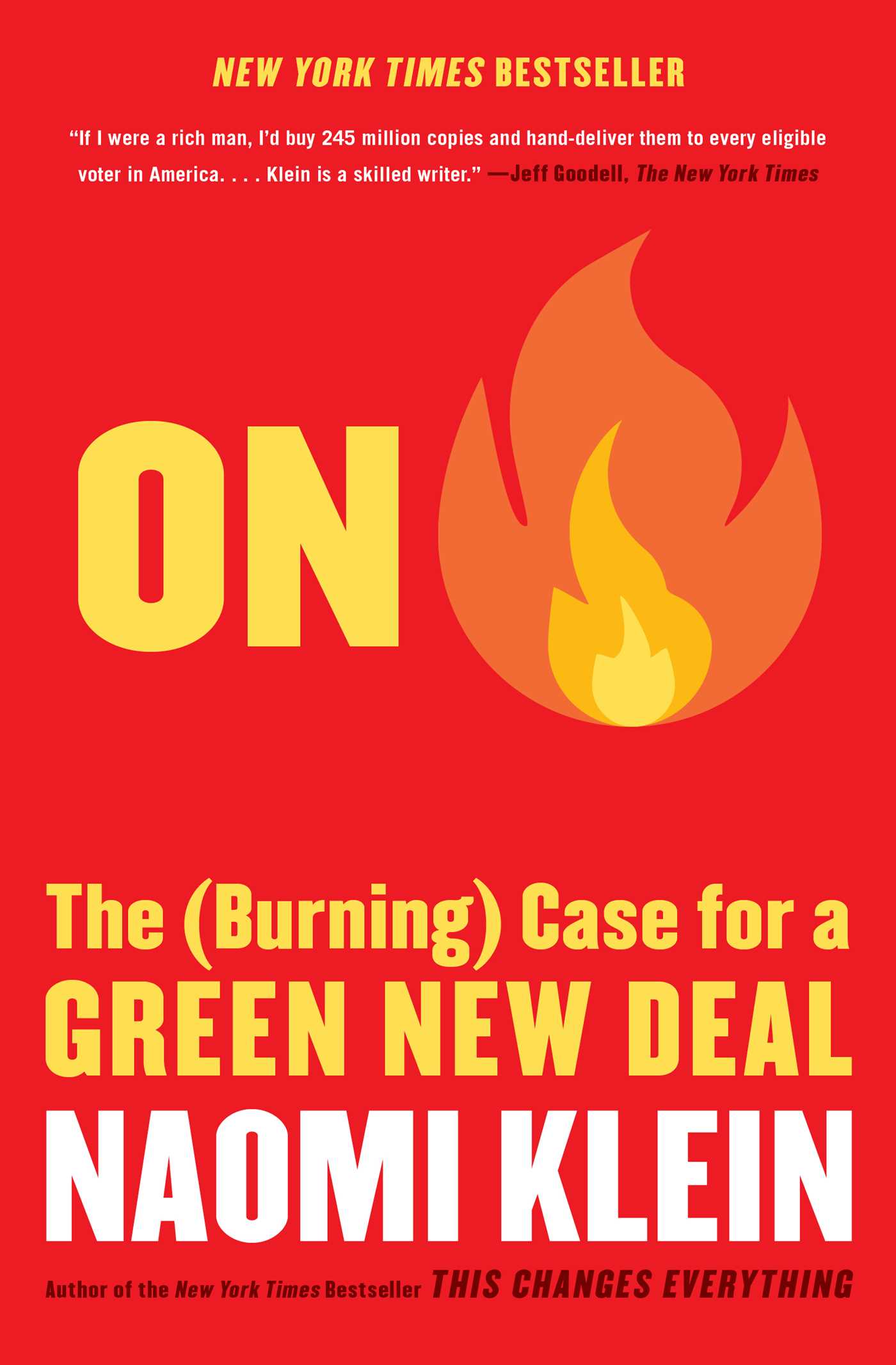
On Fire #1 New York Times and internationally bestselling author Naomi Klein makes the case for a Green New Deal in this “keenly argued, well-researched, and impassioned†manifesto (The Washington Post). An instant bestseller, On Fire shows Klein at her most prophetic and philosophical, investigating the climate crisis not only as a profound political challenge but also as a spiritual and imaginative one. Delving into topics ranging from the clash between ecological time and our culture of “perpetual now,†to the soaring history of humans changing and evolving rapidly in the face of grave threats, to rising white supremacy and fortressed borders as a form of “climate barbarism,†this is a rousing call to action for a planet on the brink. An expansive, far-ranging exploration that sees the battle for a greener world as indistinguishable from the fight for our lives, On Fire captures the burning urgency of the climate crisis, as well as the fiery energy of a rising political movement demanding a catalytic Green New Deal. “Naomi Klein’s work has always moved and guided me. She is the great chronicler of our age of climate emergency, an inspirer of generations.†—Greta Thunberg, climate activist "If I were a rich man, I’d buy 245 million copies of Naomi Klein’s 'On Fire' and hand-deliver them to every eligible voter in America…Klein is a skilled writer." —Jeff Goodell, The New York Times POLITICAL SCIENCE,Public Policy,Environmental Policy

Global Ecopolitics This book introduces students to the complex policy dilemmas related to solving global environmental problems today. POLITICAL SCIENCE,Public Policy,Environmental Policy
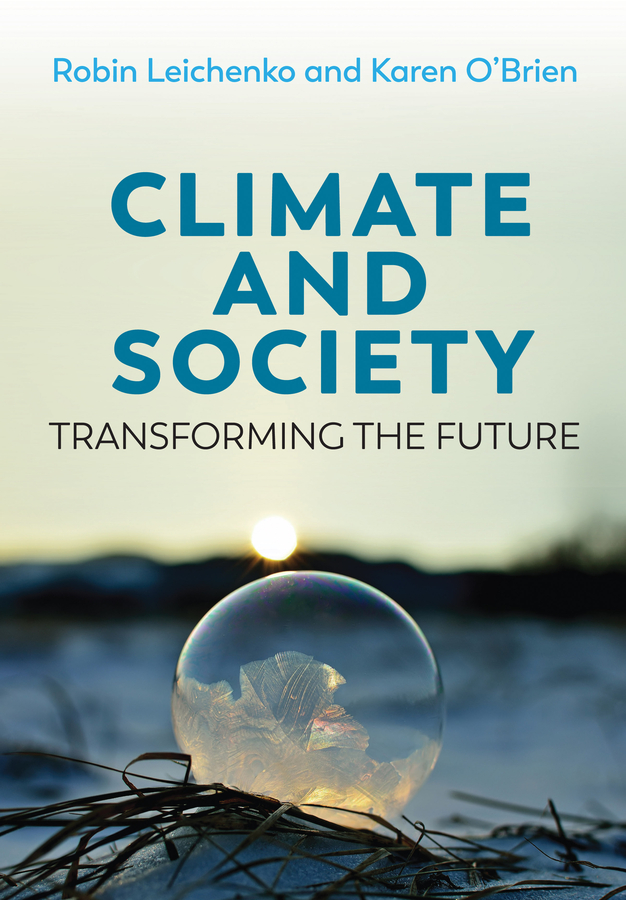
Climate and Society This bold and important new book presents current and emerging thinking on the social dimensions of climate change. Using clear language and powerful examples, it introduces key concepts and frameworks for understanding the multifaceted connections between climate and society. Robin Leichenko and Karen O’Brien frame climate change as a social issue that calls for integrative approaches to research, policy, and action. They explore dominant and relevant discourses on the social drivers and impacts of climate change, highlighting the important roles that worldviews and beliefs play in shaping responses to climate challenges. Situating climate change within the context of a rapidly changing world, the book demonstrates how dynamic political, economic, and environmental contexts amplify risks yet also present opportunities for transformative responses. Aimed at undergraduate students and others concerned with a critical challenge of our time, this informative and engaging book empowers readers with a range of possibilities for equitable and sustainable transformations in a changing climate. POLITICAL SCIENCE,Public Policy,Environmental Policy

Environmental Policy Authoritative and trusted, Environmental Policy once again brings together top scholars to evaluate the changes and continuities in American environmental policy since the late 1960s and their implications for the twenty-first century. You will learn to decipher the underlying trends, institutional constraints, and policy dilemmas that shape today’s environmental politics. The Tenth Edition examines how policy has changed within federal institutions and state and local governments, as well as how environmental governance affects private sector policies and practices. The book provides in-depth examinations of public policy dilemmas including fracking, food production, urban sustainability, and the viability of using market solutions to address policy challenges. Students will also develop a deeper understanding of global issues such as climate change governance, the implications of the Paris Agreement, and the role of environmental policy in the developing world. Students walk away with a measured yet hopeful evaluation of the future challenges policymakers will confront as the American environmental movement continues to affect the political process. POLITICAL SCIENCE,Public Policy,Environmental Policy
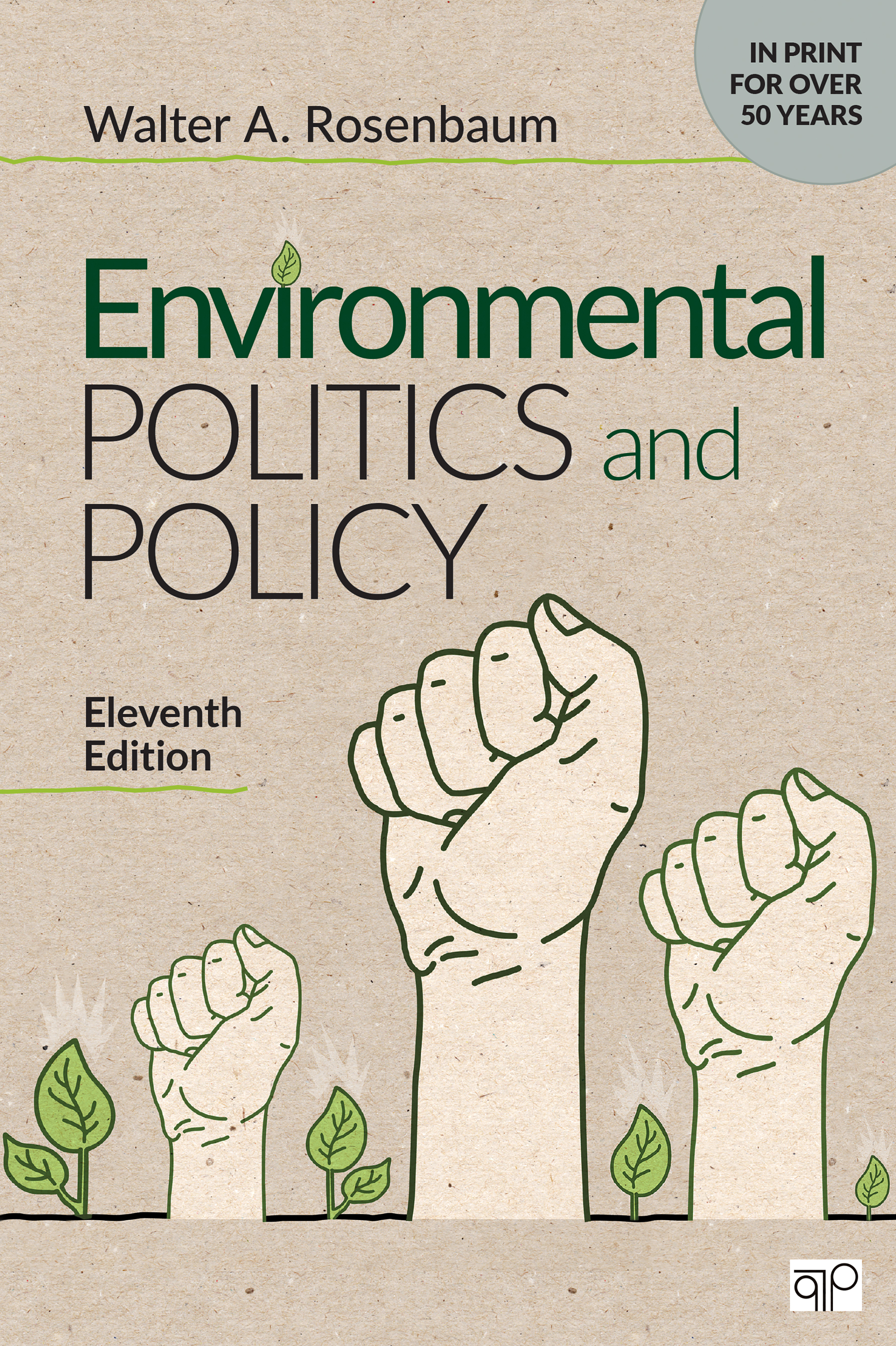
Environmental Politics and Policy Walter A. Rosenbaum’s classic Environmental Politics and Policy provides definitive coverage of environmental politics and policy, lively case material, and a balanced assessment of current environmental issues. The first half of the book sets needed context and describes the policy process while the second half covers specific environmental issues such as air and water; toxic and hazardous substances; energy; and a global policymaking chapter focused on climate change and trans-boundary politics. The eleventh edition includes updates on the Trump administration's initiatives and controversies with regard to environmental policy, offering the currency and relevancy needed for any environmental politics course. POLITICAL SCIENCE,Public Policy,Environmental Policy

The Environmental Case Answers to environmental issues are not black and white. Debates around policy are often among those with fundamentally different values, and the way that problems and solutions are defined plays a central role in shaping how those values are translated into policy. The Environmental Case captures the real-world complexity of creating environmental policy, and this much-anticipated Fifth Edition contains fifteen carefully constructed cases. Through her analysis, Sara Rinfret explores the background, players, contributing factors, and outcomes of each case, and gives readers insight into some of the most interesting and controversial issues in U.S. environmental policymaking. POLITICAL SCIENCE,Public Policy,Environmental Policy
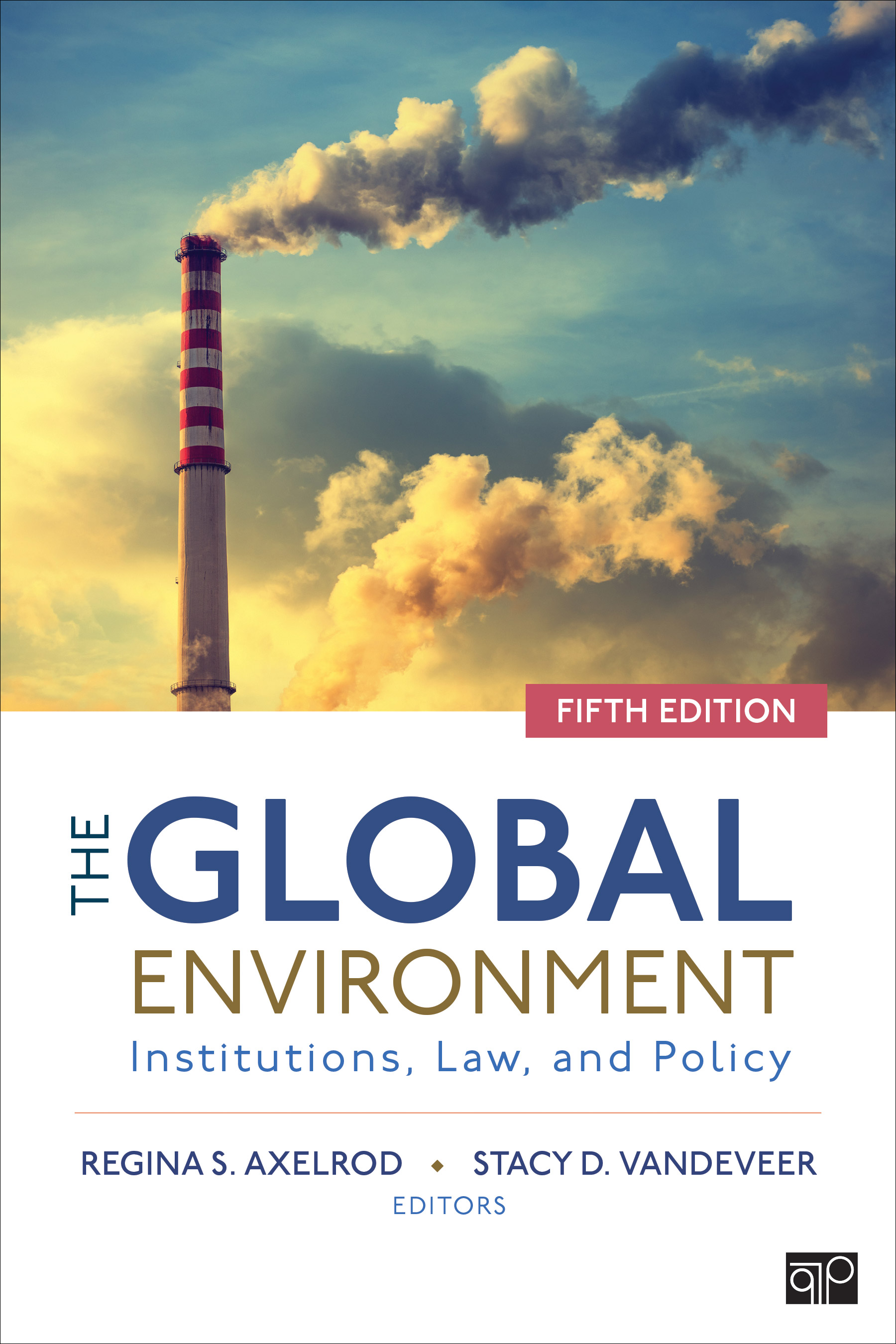
The Global Environment The new edition of The Global Environment: Institutions, Law, and Policy by Regina S. Axelrod and Stacy D. VanDeveer reflects the latest events in the in global environmental politics and sustainable development, while providing balanced coverage of the key institutions, environmental issues, treaties, and policies. This award-winning book highlights global environmental institutions, major state and non-state actors, and includes a wide range of cases such as climate change, biodiversity, hazardous chemicals, ozone layer depletion, nuclear energy and resource consumption. POLITICAL SCIENCE,Public Policy,Environmental Policy

Winning the Green New Deal An urgent and definitive collection of essays from leaders and experts championing the Green New Deal—and a detailed playbook for how we can win it—including contributions by leading activists and progressive writers like Varshini Prakash, Rhiana Gunn-Wright, Bill McKibben, Rev William Barber II, and more. In October 2018, scientists warned that we have less than 12 years left to transform our economy away from fossil fuels, or face catastrophic climate change. At that moment, there was no plan in the US to decarbonize our economy that fast. Less than two years later, every major Democratic presidential candidate has embraced the vision of the Green New Deal—a rapid, vast transformation of our economy to avert climate catastrophe while securing economic and racial justice for all. What happened? A new generation of leaders confronted the political establishment in Washington DC with a simple message: the climate crisis is here, and the Green New Deal is our last, best hope for a livable future. Now comes the hard part: turning that vision into the law of the land. In Winning a Green New Deal, leading youth activists, journalists, and policymakers explain why we need a transformative agenda to avert climate catastrophe, and how our movement can organize to win. Featuring essays by Varshini Prakash, cofounder of Sunrise Movement; Rhiana Gunn-Wright, Green New Deal policy architect; Joseph Stiglitz, Nobel Prize–winning economist; Bill McKibben, internationally renowned environmentalist; Mary Kay Henry, the President of the Service Employees International Union, and others we’ll learn why the climate crisis cannot be solved unless we also confront inequality and racism, how movements can redefine what’s politically possible and overcome the opposition of fossil fuel billionaires, and how a Green New Deal will build a just and thriving economy for all of us. For anyone looking to understand the movement for a Green New Deal, and join the fight for a livable future, there is no resource as clear and practical as Winning the Green New Deal. POLITICAL SCIENCE,Public Policy,Environmental Policy

The Green New Deal and Beyond A clear and urgent call for the national, social, and individual changes required to prevent catastrophic climate change. POLITICAL SCIENCE,Public Policy,Environmental Policy
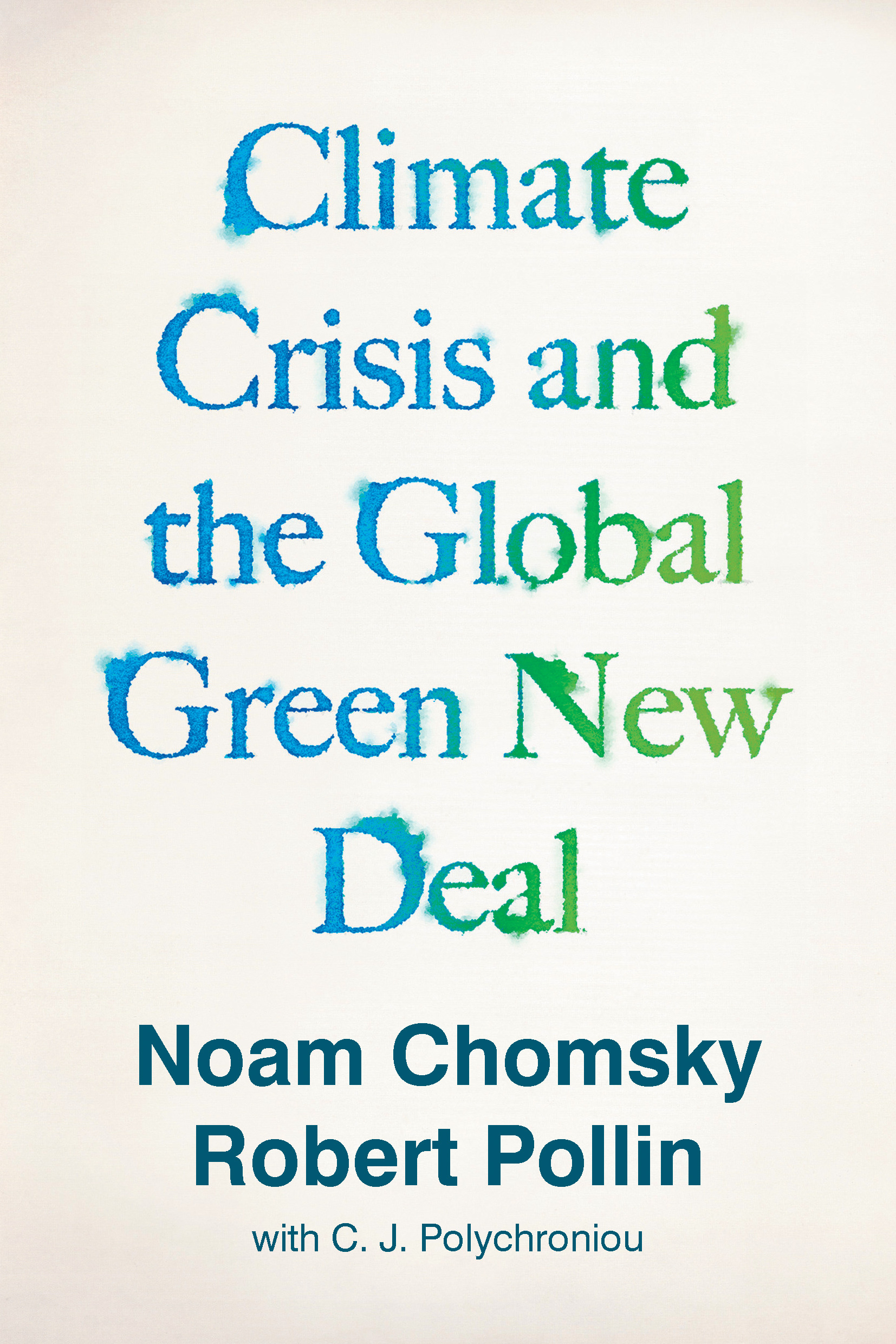
Climate Crisis and the Global Green New Deal Climate change: watershed or endgame? In this compelling new book, Noam Chomsky, the world’s leading public intellectual, and Robert Pollin, a renowned progressive economist, map out the catastrophic consequences of unchecked climate change—and present a realistic blueprint for change: the Green New Deal. Together, Chomsky and Pollin show how the forecasts for a hotter planet strain the imagination: vast stretches of the Earth will become uninhabitable, plagued by extreme weather, drought, rising seas, and crop failure. Arguing against the misplaced fear of economic disaster and unemployment arising from the transition to a green economy, they show how this bogus concern encourages climate denialism. Humanity must stop burning fossil fuels within the next thirty years and do so in a way that improves living standards and opportunities for working people. This is the goal of the Green New Deal and, as the authors make clear, it is entirely feasible. Climate change is an emergency that cannot be ignored. This book shows how it can be overcome both politically and economically. POLITICAL SCIENCE,Public Policy,Environmental Policy
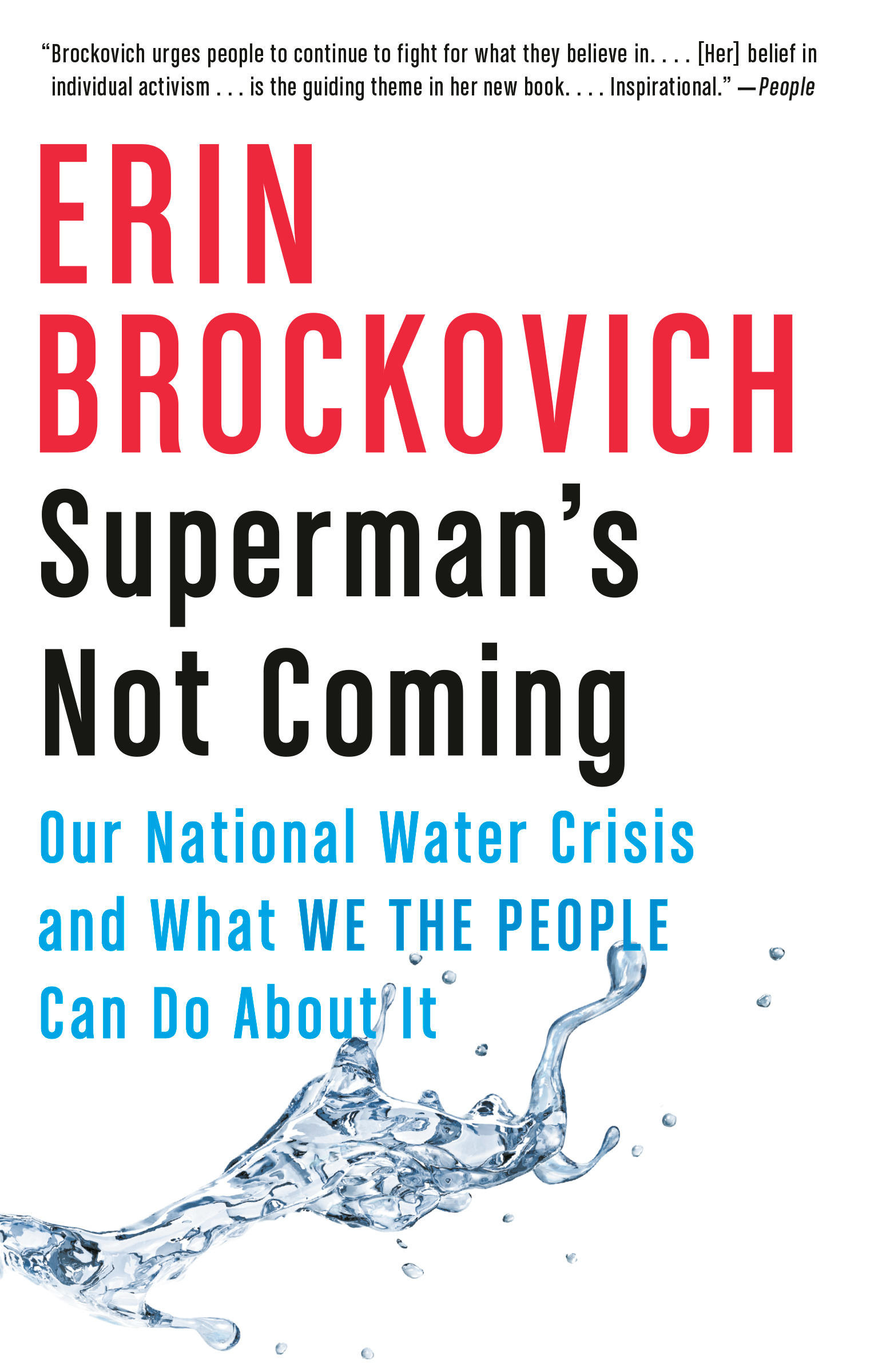
Superman's Not Coming From environmental activist, renowned crusader, champion fighter, maverick—a book that looks at our present situation with water and shows us how we can each take action to make changes in our cities, towns, and villages, before it is too late. "Brockovich is a vocal, no-nonsense writer--Roberts might even have downplayed her fire in the movie ... The tales she tells show how addressing water issues at the source can make a big difference all the way down the chain."--Heather Hansman, Outside "Brockovich urges people to continue to fight for what they believe in ... [Her] belief in individual activism--rather than relying on leaders, corporations, or the government to handle the water crisis--is the guiding theme in her new book ... inspirational."--Sam Gillette, People In Erin Brockovich’s long-awaited book—her first to reckon with conditions on our planet—she makes clear why we are in the trouble we’re in, and how, in large and practical ways, we each can take actions to bring about change. She shows us what's at stake, and writes of the fraudulent science that disguises these issues, along with cancer clusters not being reported. She writes of the saga of PG&E that continues to this day, and of the communities and people she has worked with who have helped to make an impact. She writes of the water operator in Poughkeepsie, New York, who responded to his customers' concerns and changed his system to create some of the safest water in the country; of the moms in Hannibal, Missouri, who became the first citizens in the nation to file an ordinance prohibiting the use of ammonia in their public drinking water; and about how we can protect our right to clean water by fighting for better enforecement of the laws, new legislation, and better regulations. She cannot fight all battles for all people and gives us the tools to take actions ourselves, have our voices heard, and know that steps are being taken to make sure our water is safe to drink and use. POLITICAL SCIENCE,Public Policy,Environmental Policy
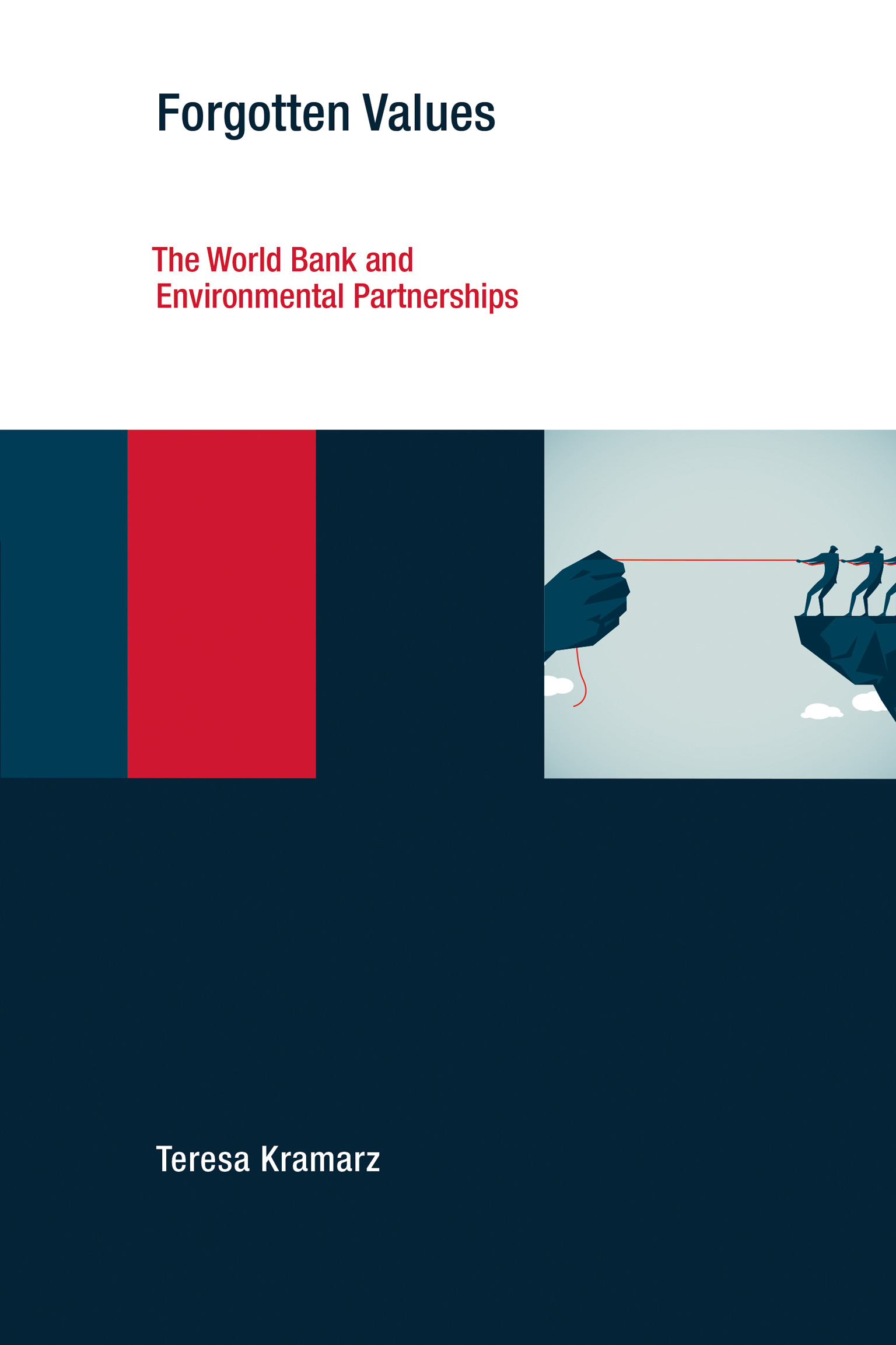
Forgotten Values An examination of the conflict between values and bureaucracy in World Bank biodiversity partnerships that sheds light on this model of global environmental governance. Multi-stakeholder partnerships have become an increasingly common form of global governance. Partnerships, usually between international organizations (IOs) or state agencies and such private actors as NGOs, businesses, and academic institutions, have even been promoted as the gold standard of good governance--participatory, innovative, and well-funded. And yet these partnerships often fail to live up to the values that motivated their establishment. In this book, Teresa Kramarz examines this gap between promise and performance by analyzing partnerships in biodiversity conservation initiatives launched by the World Bank. POLITICAL SCIENCE,Public Policy,Environmental Policy
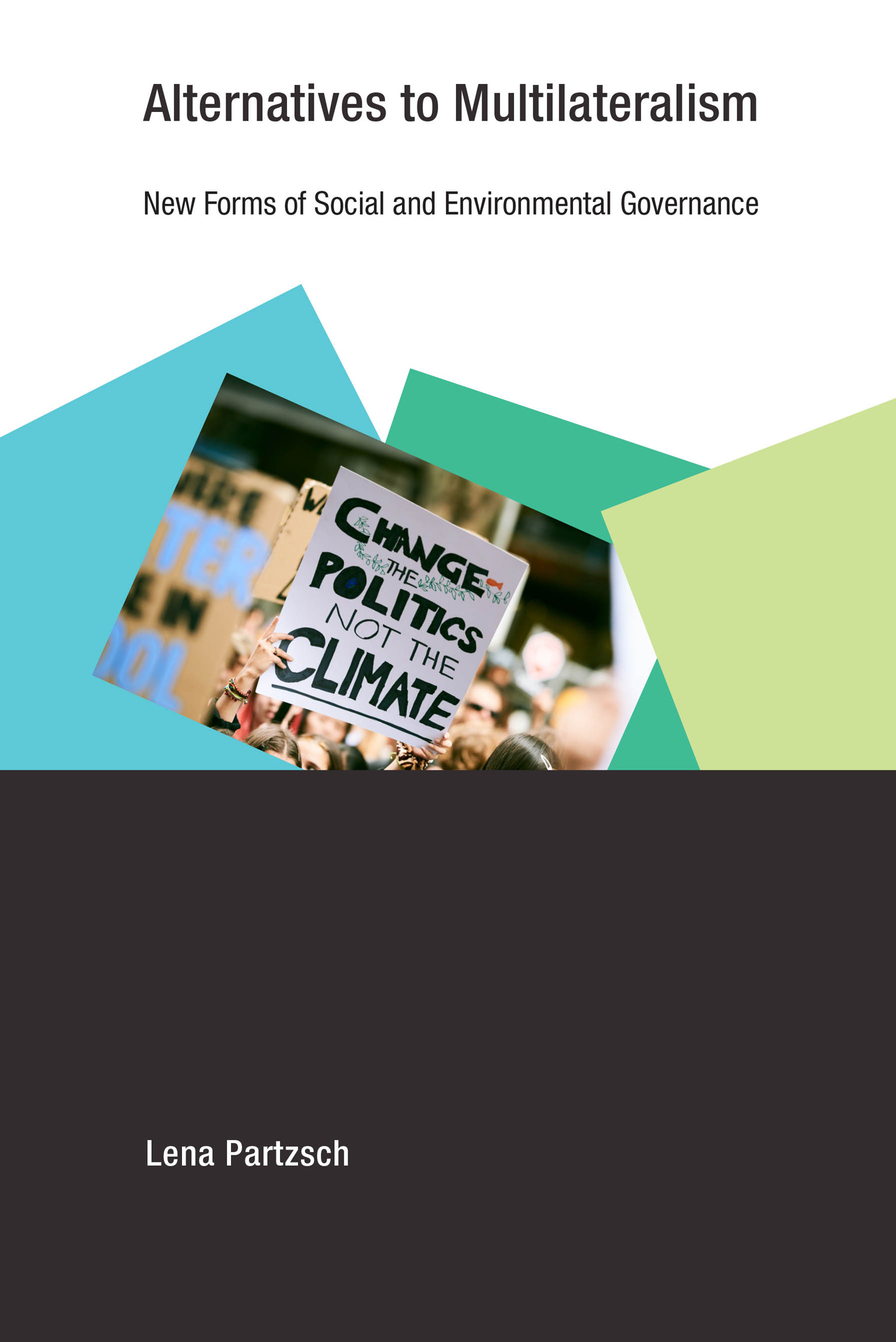
Alternatives to Multilateralism Analysis and case studies of emerging forms of private, public, and hybrid social and environmental governance. The effects of globalization on governance are complex and uncertain. As markets integrate, governments have become increasingly hesitant to enforce regulations inside their own jurisdictions. At the same time, multilateralism has proven unsuccessful in coordinating states' responses to global challenges. In this book, Lena Partzsch describes alternatives to multilateralism, offering analyses and case studies of emerging--alternative--forms of private, public, and hybrid social and environmental regulation. In doing so, she offers a unique overview of cutting-edge approaches to global governance. POLITICAL SCIENCE,Public Policy,Environmental Policy
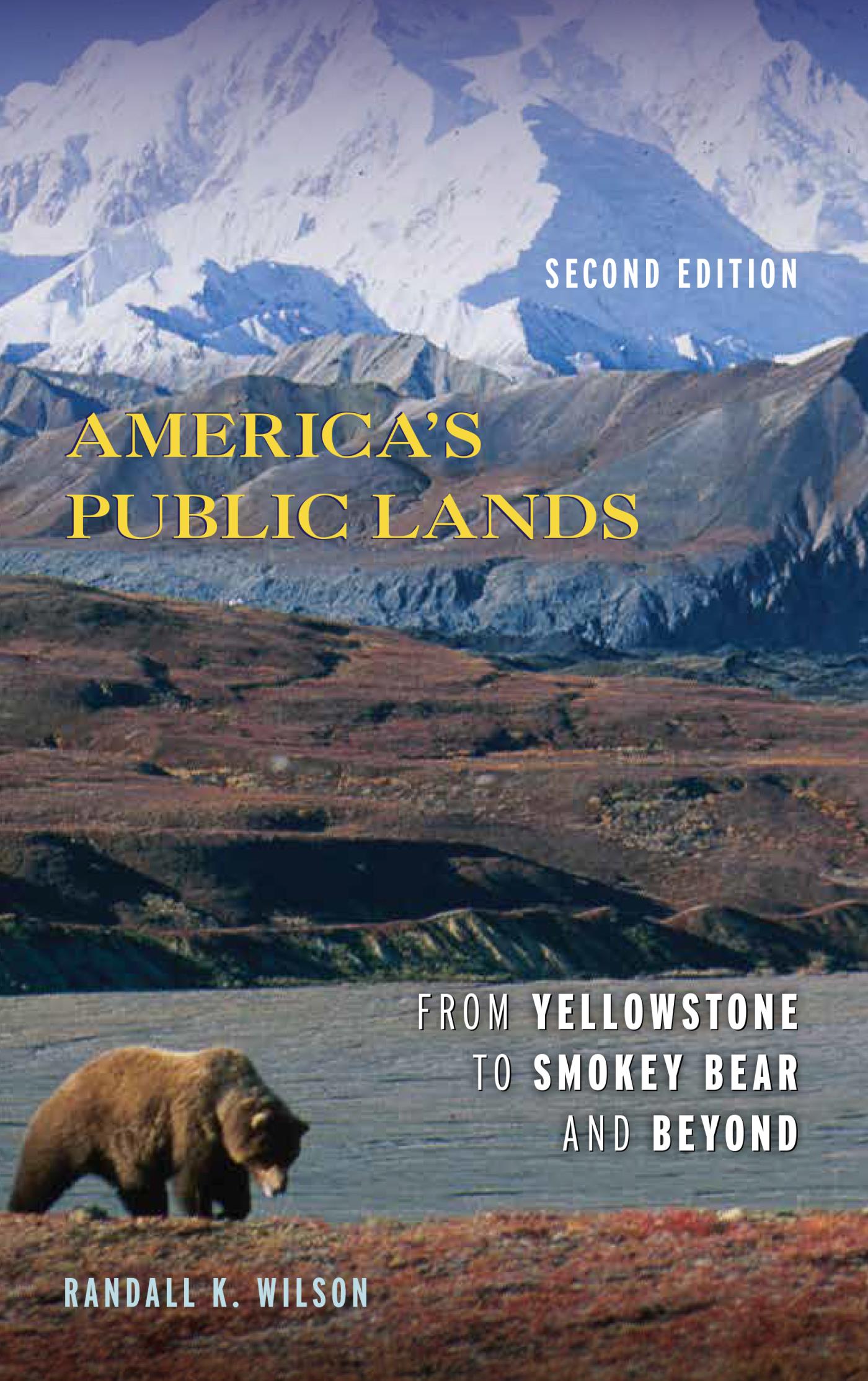
America's Public Lands This updated edition traces the oft-forgotten ideas of nature that have shaped the evolution of America’s public land system. The result is a fresh and compelling account of the most pressing challenges facing national parks, forests, rangelands, and wildlife refuges from their early beginnings through the first years of the Trump administration. POLITICAL SCIENCE,Public Policy,Environmental Policy
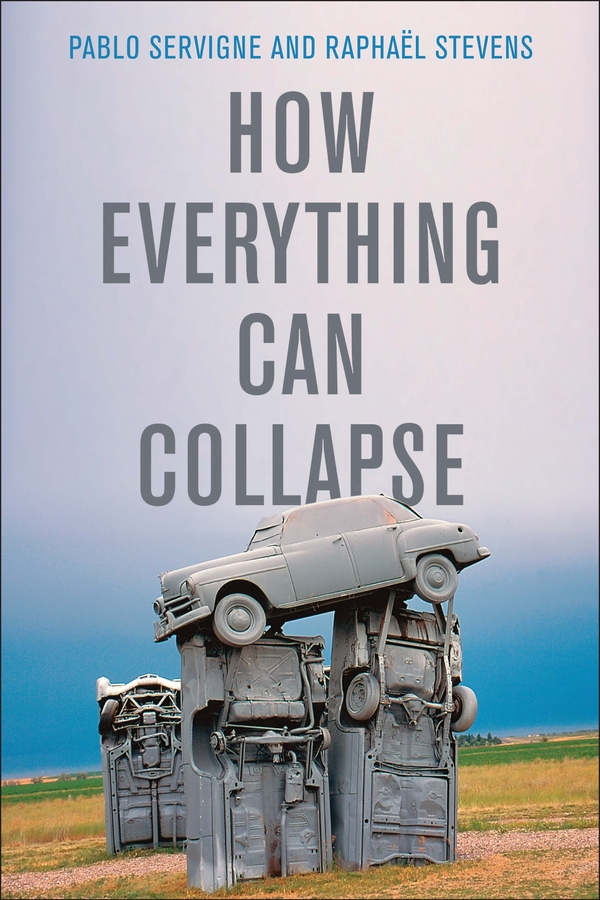
How Everything Can Collapse What if our civilization were to collapse? Not many centuries into the future, but in our own lifetimes? Most people recognize that we face huge challenges today, from climate change and its potentially catastrophic consequences to a plethora of socio-political problems, but we find it hard to face up to the very real possibility that these crises could produce a collapse of our entire civilization. Yet we now have a great deal of evidence to suggest that we are up against growing systemic instabilities that pose a serious threat to the capacity of human populations to maintain themselves in a sustainable environment. In this important book, Pablo Servigne and Raphaël Stevens confront these issues head-on. They examine the scientific evidence and show how its findings, often presented in a detached and abstract way, are connected to people’s ordinary experiences – joining the dots, as it were, between the Anthropocene and our everyday lives. In so doing they provide a valuable guide that will help everyone make sense of the new and potentially catastrophic situation in which we now find ourselves. Today, utopia has changed sides: it is the utopians who believe that everything can continue as before, while realists put their energy into making a transition and building local resilience. Collapse is the horizon of our generation. But collapse is not the end – it’s the beginning of our future. We will reinvent new ways of living in the world and being attentive to ourselves, to other human beings and to all our fellow creatures. POLITICAL SCIENCE,Public Policy,Environmental Policy
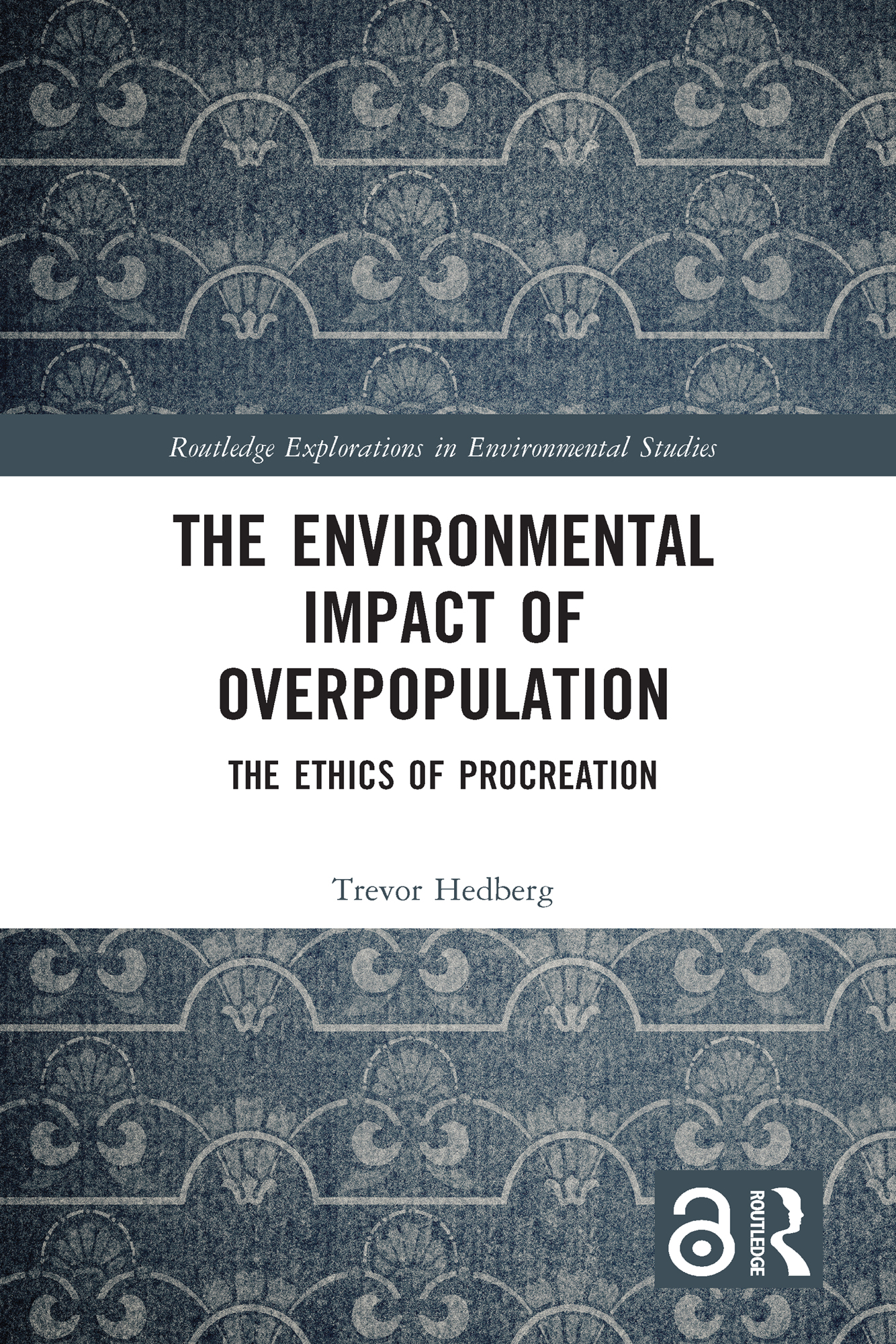
The Environmental Impact of Overpopulation This book examines the link between population growth and environmental impact and explores the implications of this connection for the ethics of procreation. In light of climate change, species extinctions, and other looming environmental crises, Trevor Hedberg argues that we have a collective moral duty to halt population growth to prevent environmental harms from escalating. This book assesses a variety of policies that could help us meet this moral duty, confronts the conflict between protecting the welfare of future people and upholding procreative freedom, evaluates the ethical dimensions of individual procreative decisions, and sketches the implications of population growth for issues like abortion and immigration. It is not a book of tidy solutions: Hedberg highlights some scenarios where nothing we can do will enable us to avoid treating some people unjustly. In such scenarios, the overall objective is to determine which of our available options will minimize the injustice that occurs. This book will be of great interest to those studying environmental ethics, environmental policy, climate change, sustainability, and population policy. POLITICAL SCIENCE,Public Policy,Environmental Policy
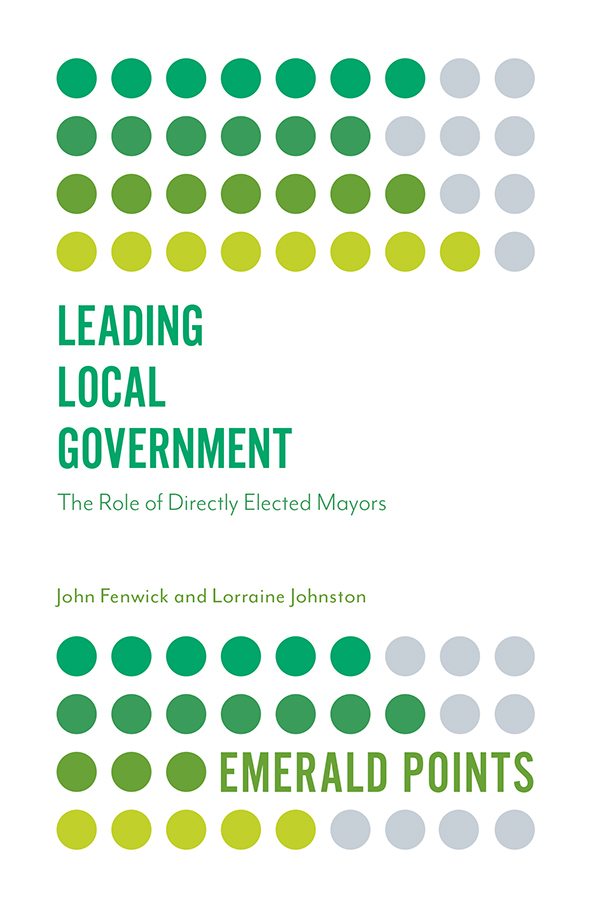
Leading Local Government Leading Local Government: The Role of Directly Elected Mayors provides a critical assessment of the role occupied by directly elected mayors in the leadership of English local government. Built on original research and historical analysis, the book examines the impact of elected mayors upon public engagement, devolution and local leadership. POLITICAL SCIENCE,Public Policy,Environmental Policy

Horsemen of the Apocalypse From the New York Times bestselling author Dick Russell, edited and introduced by New York Times bestselling author Robert F. Kennedy, Jr.! â€A must read for anyone concerned with climate and energy issues.†—Leonardo DiCaprio, Academy Award winning actor and environmental activist The science is overwhelming; the facts are in. The planet is heating up at an alarming rate and the results are everywhere to be seen. Yet, as time runs out, climate progress is blocked by the men who are profiting from the burning of the planet: energy moguls like the Koch brothers and Exxon Mobil CEO Rex Tillerson. Powerful politicians like Senators Mitch McConnell and Jim Inhofe, who receive massive contributions from the oil and coal industries. Most of these men are too intelligent to truly believe that climate change is not a growing crisis. And yet they have put their profits and careers ahead of the health and welfare of the world’s population—and even their own children and grandchildren. How do they explain themselves to their offspring, to the next generations that must deal with the environmental havoc that these men have wreaked? Horsemen of the Apocalypse takes a personal look at this global crisis, literally bringing it home. POLITICAL SCIENCE,Public Policy,Environmental Policy
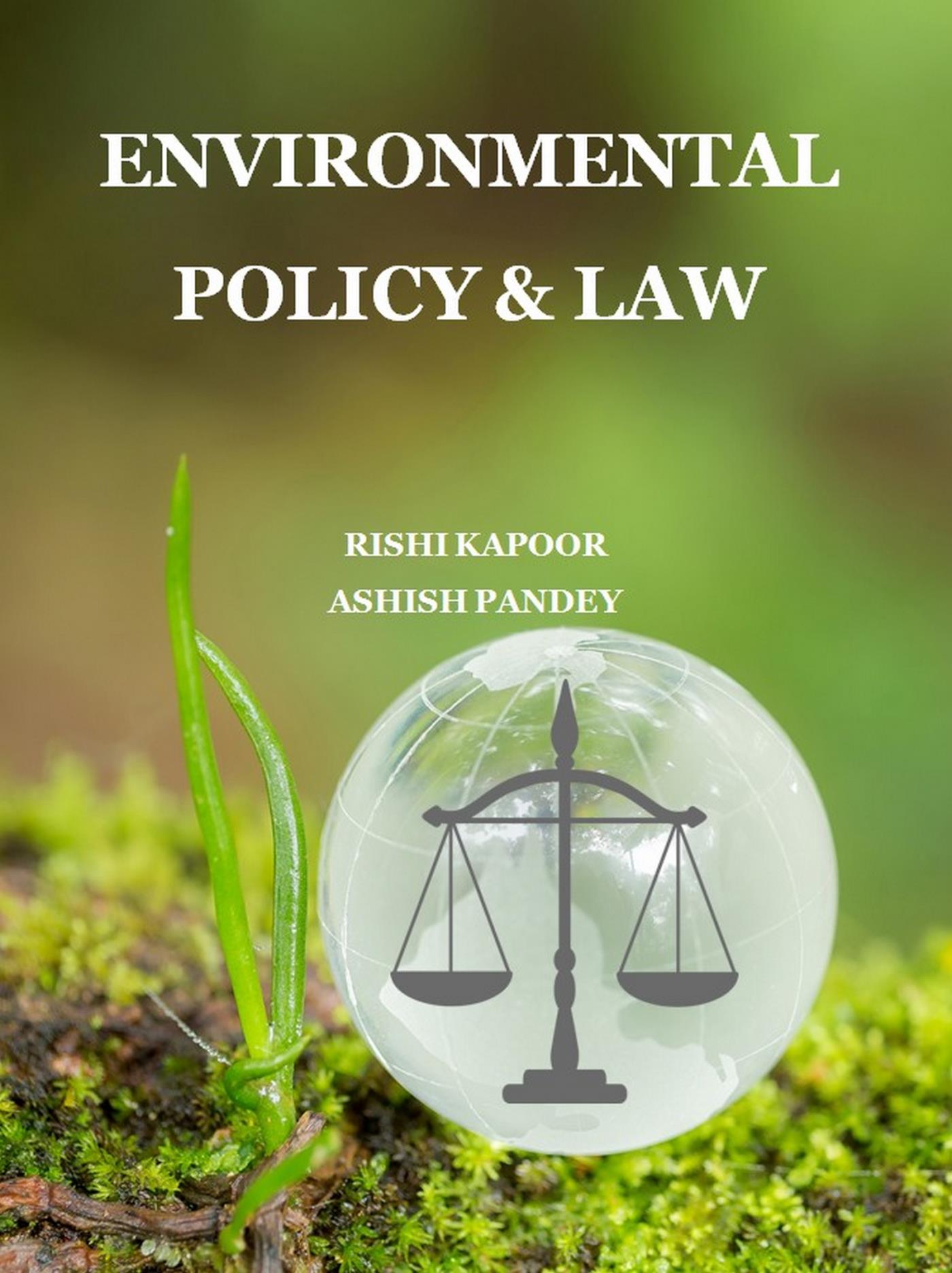
Environmental Policy And Law In the Directive Principles of State Policy, Article 48 (A) says "the state shall endeavour to protect and improve the environment and to safeguard the forests and wildlife of the country"; Article 51-A (g) states that "it shall be the duty of every citizen of India to protect and improve the natural environment including forests, lakes, rivers and wildlife and to have compassion for living creatures. This book “Environmental Policy and Law†is an attempt to compile the available information related to Environmental Policies and laws introduced, created and amended time to time for the welfare of human beings, wildlife, forests and animals. The text is also included legal approach to control pollution and conserve forest. While writing this book, the authors have put an effort to explain all policies and laws to control environmental pollutions and to protect & conserve our Wild life & Forests. This text also describes the Hon’ble Supreme Court and Hon’ble National Green Tribunal’s approach and guidelines issued time & again for safeguarding Environment. It also highlights the major decisions passed on control of types of Environmental pollution with a brief description of all the judgments passed till date by the various Courts. This book is useful for common men, teachers, policy makers, researchers and students of Botany, Zoology, Agriculture, Forestry, Geography, Geology, Law and Environmental Sciences. POLITICAL SCIENCE,Public Policy,Environmental Policy
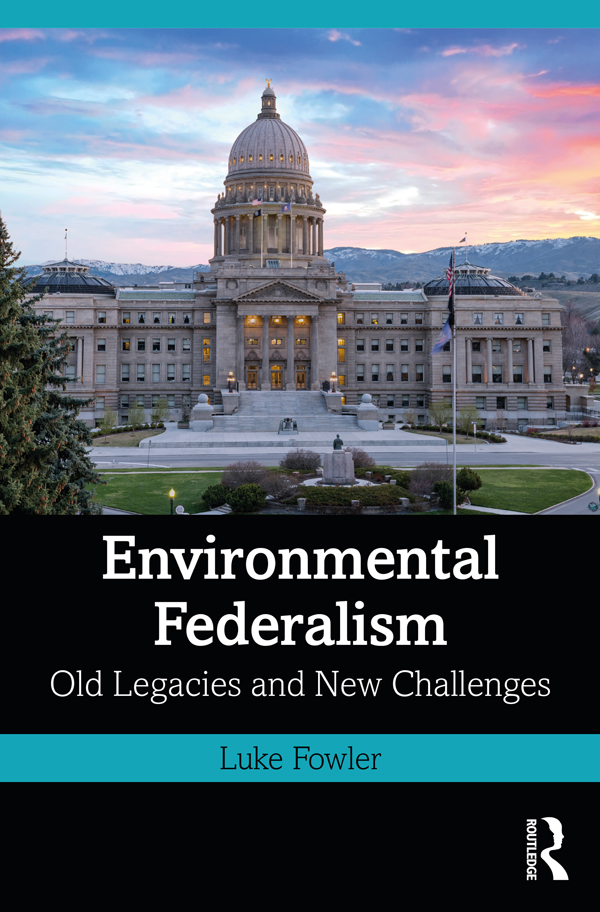
Environmental Federalism In Environmental Federalism, Luke Fowler helps to refocus much-needed attention on the role of state governments in environmental policy creation and implementation in the United States. While the national government receives most of the attention when it comes to environmental policy, state governments play a vital role in protecting our natural resources. Legacy problems, like air, water, and land pollution, present one set of challenges for environmental federalism, but new problems emerging as a result of climate change further test the bounds of federal institutions. Examining patterns of pollution and case studies from the Clean Air Act and the Clean Water Act, Fowler explores two questions: has environmental federalism worked in managing legacy environmental problems, and can it work to manage climate change? In order to answer these questions, Fowler extends James Lester’s typology using political incentives and administrative capacities to identify four types of states (progressive, delayers, strugglers, and regressives) and assesses how they are linked to the success of federal environmental programs and conf licts in intergovernmental relations. He then considers what lessons we can learn from these programs and whether those lessons can help us better understand climate policy and multi-level institutions for environmental governance. This timely read will be a valuable contribution to students, researchers, and scholars of political science, public policy, public administration, and environmental studies. POLITICAL SCIENCE,Public Policy,Environmental Policy
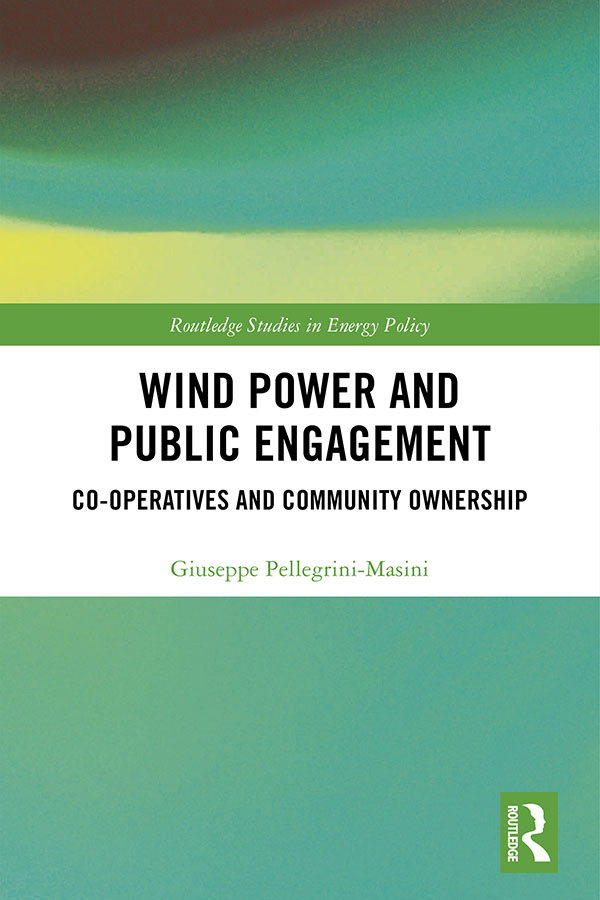
Wind Power and Public Engagement Adopting an interdisciplinary social science approach, this book examines community reactions to wind farms to form a new understanding of what facilitates social acceptance. Based on empirical research, Wind Power and Public Engagement investigates opposition to wind energy and considers the advantages as well as the limits of the co-operative model of wind farm community ownership. Giuseppe Pellegrini-Masini compares the role of co-operative schemes with community benefits schemes in increasing acceptability, and also sheds light on the impact of social factors including pro-environmental attitudes, perceived benefits and costs, place attachment, trust, as well as individuals’ resources such as information and income. Five research cases are investigated in England and Scotland, including the first local, community-owned wind farm co-operative in the UK. Critically reviewing existing social research theories, the book offers a new viewpoint, integrating rational choice and environmental attitudinal theories, from which to assess and understand the social acceptability of wind energy. It also highlights new opportunities for raising consensus in communities around locally proposed wind farms. The book will be of great interest to students and scholars of renewable energy, energy policy, environmental sociology, environmental psychology, environmental planning and sustainability in general, as well as policymakers. POLITICAL SCIENCE,Public Policy,Environmental Policy
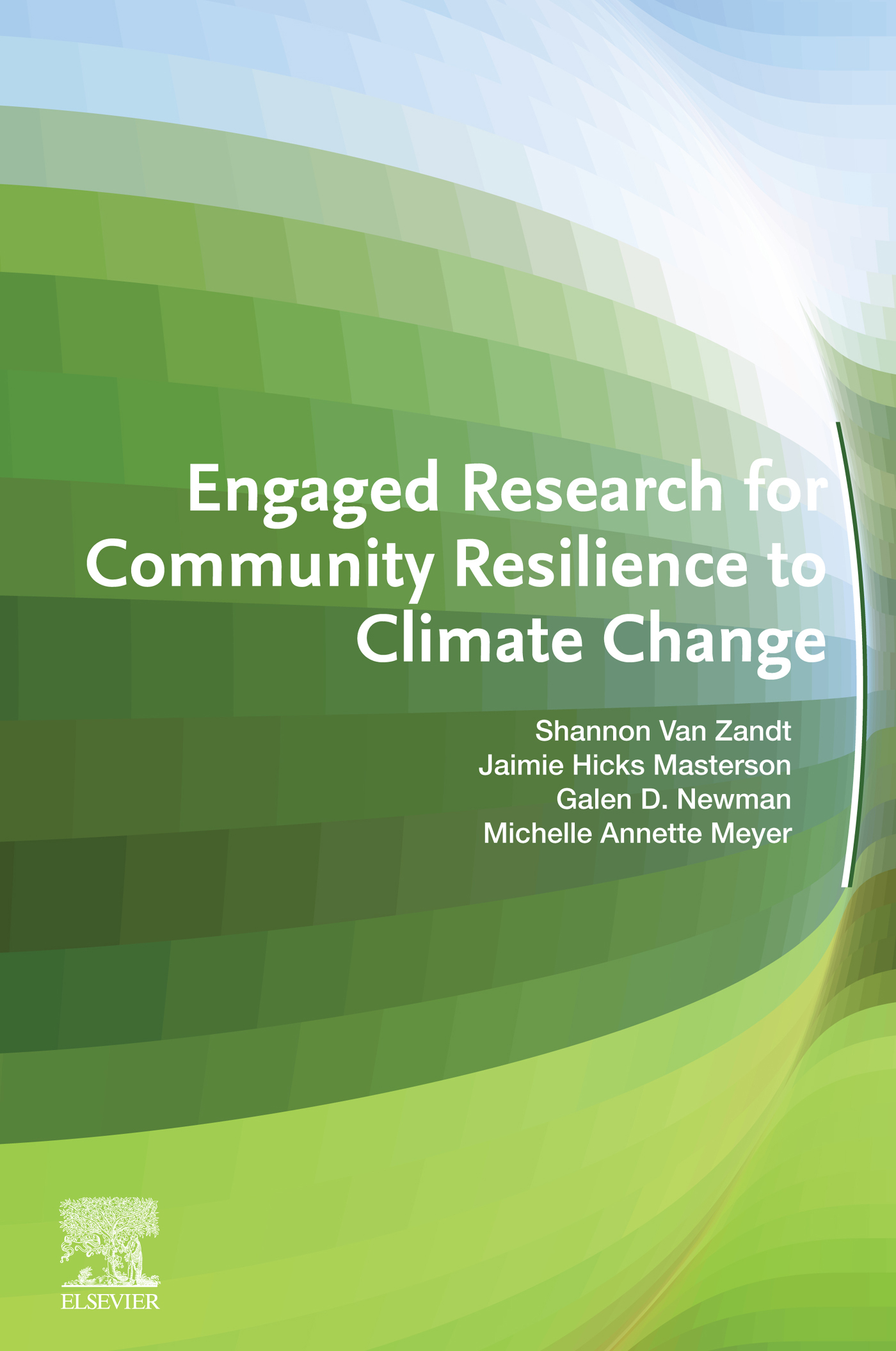
Engaged Research for Community Resilience to Climate Change Engaged Research for Community Resilience to Climate Change is a guide to successfully integrating science into urban, regional, and coastal planning activities to build truly sustainable communities that can withstand climate change. It calls for a shift in academic researchers’ traditional thinking by working across disciplines to solve complex societal and environmental problems, focusing on the real-world human impacts of climate change, and providing an overview of how science can be used to advocate for institutional change. Engaged Research for Community Resilience to Climate Change appeals to a wide variety of audiences, including university administrators looking to create and sustain interdisciplinary research groups, community and state officials, non-profit and community advocates, and community organizers seeking guidance for generating and growing meaningful, productive relationships with university researchers to support change in their communities. Focuses on the process of building a successful, active partnership between climate change researchers and climate resilience professionals Provides case studies of university-community partnerships in building climate resilience Includes interviews and contributors from a wide variety of disciplines engaged in climate resilience partnerships POLITICAL SCIENCE,Public Policy,Environmental Policy
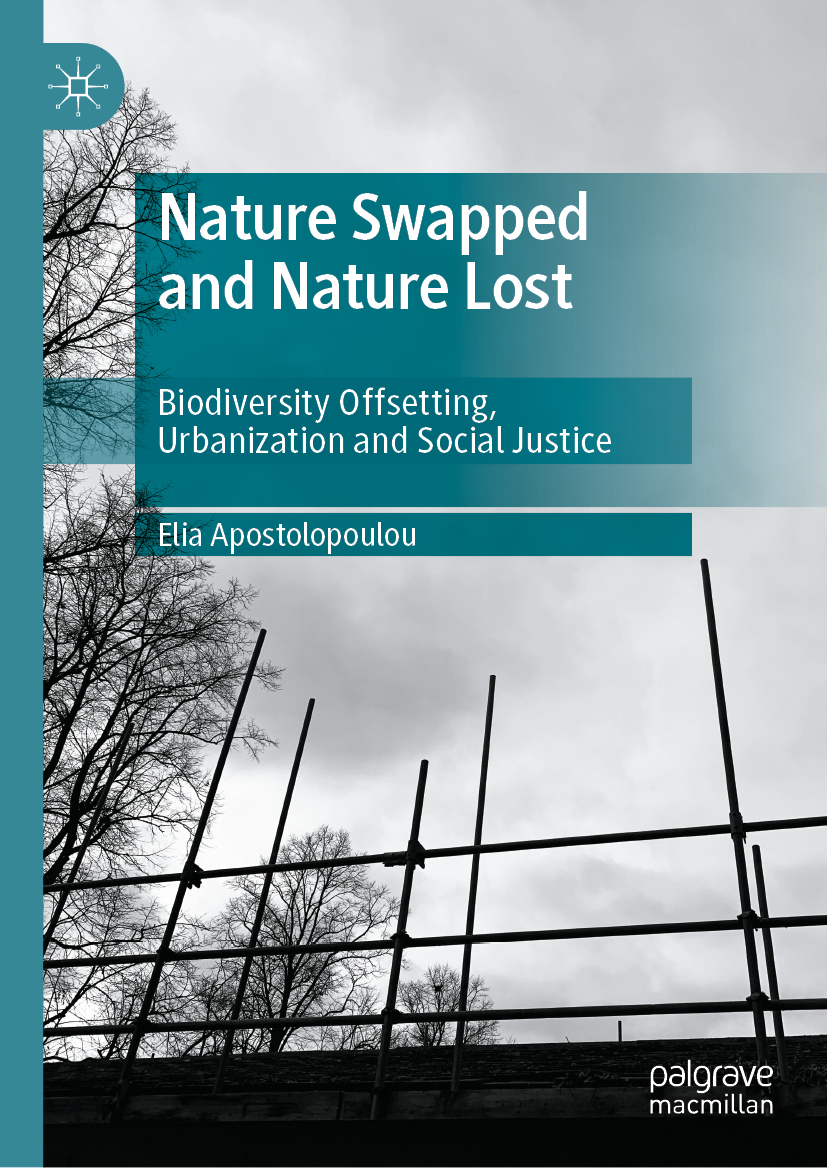
Nature Swapped and Nature Lost This book unravels the profound implications of biodiversity offsetting for nature-society relationships and its links to environmental and social inequality. Drawing on people’s resistance against its implementation in several urban and rural places across England, it explores how the production of equivalent natures, the core promise of offsetting, reframes socionatures both discursively and materially transforming places and livelihoods. The book draws on theories and concepts from human geography, political ecology, and Marxist political economy, and aims to shift the trajectory of the current literature on the interplay between offsetting, urbanization and the neoliberal reconstruction of conservation and planning policies in the era following the 2008 financial crash. By shedding light on offsetting’s contested geographies, it offers a fundamental retheorization of offsetting capable of demonstrating how offsetting, and more broadly revanchist neoliberal policies, are increasingly used to support capitalist urban growth producing socially, environmentally and geographically uneven outcomes. Nature Swapped and Nature Lost brings forward an understanding of environmental politics as class politics and sees environmental justice as inextricably linked to social justice. It effectively challenges the dystopia of offsetting’s ahistorical and asocial non-places and proposes a radically different pathway for gaining social control over the production of nature by linking struggles for the right to the city with struggles for the right to nature for all. POLITICAL SCIENCE,Public Policy,Environmental Policy
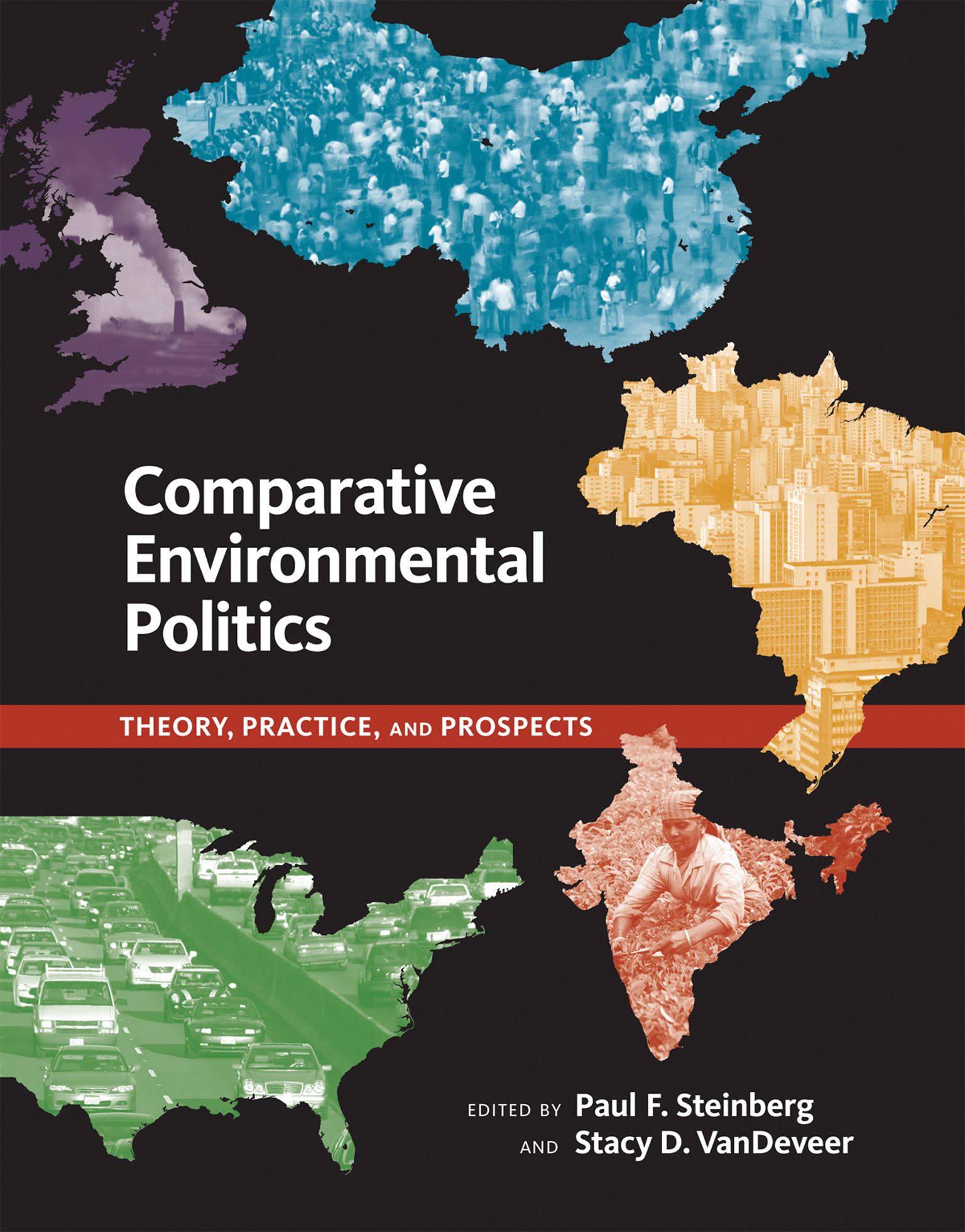
Comparative Environmental Politics Combining the theoretical tools of comparative politics with the substantive concerns of environmental policy, experts explore responses to environmental problems across nations and political systems How do different societies respond politically to environmental problems around the globe? Answering this question requires systematic, cross-national comparisons of political institutions, regulatory styles, and state-society relations. The field of comparative environmental politics approaches this task by bringing the theoretical tools of comparative politics to bear on the substantive concerns of environmental policy. This book outlines a comparative environmental politics framework and applies it to concrete, real-world problems of politics and environmental management. After a comprehensive review of the literature exploring domestic environmental politics around the world, the book provides a sample of major currents within the field, showing how environmental politics intersects with such topics as the greening of the state, the rise of social movements and green parties, European Union expansion, corporate social responsibility, federalism, political instability, management of local commons, and policymaking under democratic and authoritarian regimes. It offers fresh insights into environmental problems ranging from climate change to water scarcity and the disappearance of tropical forests, and it examines actions by state and nonstate actors at levels from the local to the continental. The book will help scholars and policymakers make sense of how environmental issues and politics are connected around the globe, and is ideal for use in upper-level undergraduateand graduate courses. POLITICAL SCIENCE,Public Policy,Environmental Policy
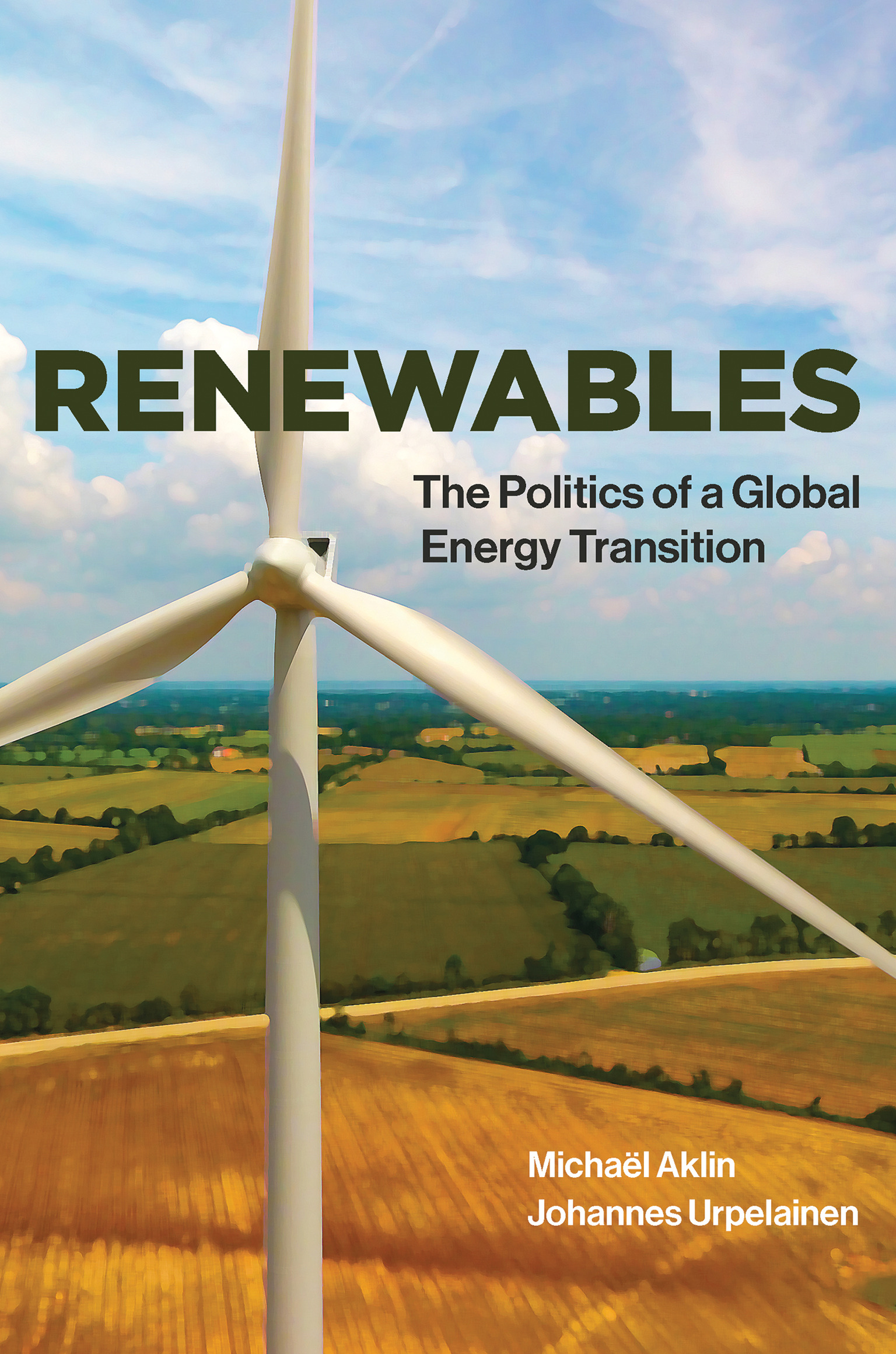
Renewables A comprehensive political analysis of the rapid growth in renewable wind and solar power, mapping an energy transition through theory, case studies, and policy. Wind and solar are the most dynamic components of the global power sector. How did this happen? After the 1973 oil crisis, the limitations of an energy system based on fossil fuels created an urgent need to experiment with alternatives, and some pioneering governments reaped political gains by investing heavily in alternative energy such as wind or solar power. Public policy enabled growth over time, and economies of scale brought down costs dramatically. In this book, Michaël Aklin and Johannes Urpelainen offer a comprehensive political analysis of the rapid growth in renewable wind and solar power, mapping an energy transition through theory, case studies, and policy analysis. Aklin and Urpelainen argue that, because the fossil fuel energy system and political support for it are so entrenched, only an external shock—an abrupt rise in oil prices, or a nuclear power accident, for example—allows renewable energy to grow. They analyze the key factors that enable renewable energy to withstand political backlash, andt they draw on this analyisis to explain and predict the development of renewable energy in different countries over time. They examine the pioneering efforts in the United States, Germany, and Denmark after the 1973 oil crisis and other shocks; explain why the United States surrendered its leadership role in renewable energy; and trace the recent rapid growth of modern renewables in electricity generation, describing, among other things, the return of wind and solar to the United States. Finally, they apply the lessons of their analysis to contemporary energy policy issues. POLITICAL SCIENCE,Public Policy,Environmental Policy

Science and Environment in Chile The politics of scientific advice across four environmental conflicts in Chile, when the state acted as a “neutral broker” rather than protecting the common good. In Science and Environment in Chile, Javiera Barandiarán examines the consequences for environmental governance when the state lacks the capacity to produce an authoritative body of knowledge. Focusing on the experience of Chile after it transitioned from dictatorship to democracy, she examines a series of environmental conflicts in which the state tried to act as a “neutral broker” rather than the protector of the common good. She argues that this shift in the role of the state—occurring in other countries as well—is driven in part by the political ideology of neoliberalism, which favors market mechanisms and private initiatives over the actions of state agencies. Chile has not invested in environmental science labs, state agencies with in-house capacities, or an ancillary network of trusted scientific advisers—despite the growing complexity of environmental problems and increasing popular demand for more active environmental stewardship. Unlike a high modernist “empire” state with the scientific and technical capacity to undertake large-scale projects, Chile's model has been that of an “umpire” state that purchases scientific advice from markets. After describing the evolution of Chilean regulatory and scientific institutions during the transition, Barandiarán describes four environmental crises that shook citizens' trust in government: the near-collapse of the farmed salmon industry when an epidemic killed millions of fish; pollution from a paper and pulp mill that killed off or forced out thousands of black-neck swans; a gold mine that threatened three glaciers; and five controversial mega-dams in Patagonia. POLITICAL SCIENCE,Public Policy,Environmental Policy

From the Inside Out An examination of why government agencies allow environmental injustices to persist. Many state and federal environmental agencies have put in place programs, policies, and practices to redress environmental injustices, and yet these efforts fall short of meeting the principles that environmental justice activists have fought for. In From the Inside Out, Jill Lindsey Harrison offers an account of the bureaucratic culture that hinders regulatory agencies' attempts to reduce environmental injustices. It is now widely accepted that America's poorest communities, communities of color, and Native American communities suffer disproportionate harm from environmental hazards, with higher exposure to pollution and higher incidence of lead poisoning, cancer, asthma, and other diseases linked to environmental ills. And yet, Harrison reports, some regulatory staff view these problems as beyond their agencies' area of concern, requiring too many resources, or see neutrality as demanding “color-blind” administration. Drawing on more than 160 interviews (with interviewees including 89 current or former agency staff members and more than 50 environmental justice activists and others who interact with regulatory agencies) and more than 50 hours of participant observation of agency meetings (both open- and closed-door), Harrison offers a unique account of how bureaucrats resist, undermine, and disparage environmental justice reform—and how environmental justice reformers within the agencies fight back by trying to change regulatory practice and culture from the inside out. Harrison argues that equity, not just aggregated overall improvement, should be a metric for evaluating environmental regulation. POLITICAL SCIENCE,Public Policy,Environmental Policy
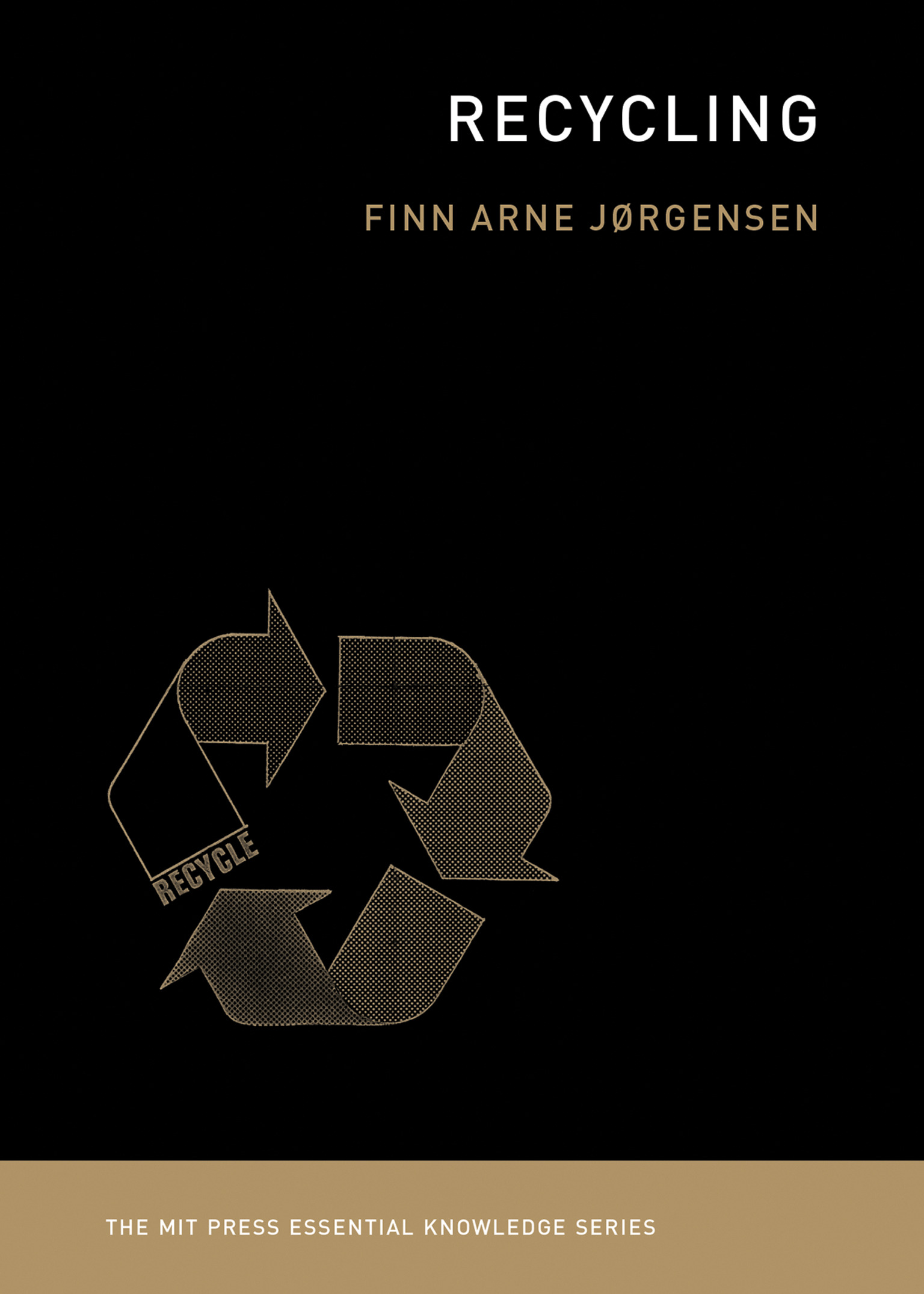
Recycling An overview of recycling as an activity and a process, following different materials through the waste stream. Is there a point to recycling? Is recycling even good for the environment? In this volume in the MIT Press Essential Knowledge series, Finn Arne Jørgensen answers (drumroll, please): it depends. From a technical point of view, recycling is a series of processes—collecting, sorting, processing, manufacturing. Recycling also has a cultural component; at its core, recycling is about transformation and value, turning material waste into something useful—plastic bags into patio furniture, plastic bottles into T-shirts. Jørgensen offers an accessible and engaging overview of recycling as an activity and as a process at the intersection of the material and the ideological. Jørgensen follows a series of materials as they move back and forth between producer and consumer, continually transforming in form and value, in a never-ceasing journey toward becoming waste. He considers organic waste and cultural contamination; the history of recyclable writing surfaces from papyrus to newsprint; discarded clothing as it moves from the the Global North to the Global South; the shifting fate of glass bottles; the efficiency of aluminum recycling; the many types of plastic and the difficulties of informed consumer choice; e-waste and technological obsolescence; and industrial waste. Finally, re-asking the question posed by John Tierney in an infamous 1996 New York Times article, “is recycling garbage?” Jørgensen argues that recycling is necessary—as both symbolic action and physical activity that has a tangible effect on the real world. POLITICAL SCIENCE,Public Policy,Environmental Policy

Governing Complex Systems An exploration of the need for innovative mechanisms of governance in an era when human actions are major drivers of environmental change. The onset of the Anthropocene, an era in which human actions have become major drivers of change on a planetary scale, has increased the complexity of socioecological systems. Complex systems pose novel challenges for governance because of their high levels of connectivity, nonlinear dynamics, directional patterns of change, and emergent properties. Meeting these challenges will require the development of new intellectual capital. In this book, Oran Young argues that to achieve sustainable outcomes in a world of complex systems, we will need governance systems that are simultaneously durable enough to be effective in guiding behavior and agile enough to adapt to rapidly changing circumstances. While some insights from past research on governance remain valid in this setting, Young argues that we need new social capital to supplement mainstream regulatory approaches that feature rule making with an emphasis on compliance and enforcement. He explores the uses of goal setting as a governance strategy, the idea of principled governance, and the role of what is often called good governance in meeting the challenges of the Anthropocene. Drawing on his long experience operating on the science/policy frontier, Young calls for more effective collaboration between analysts and practitioners in creating and implementing governance systems capable of producing sustainable outcomes in a world of complex systems. POLITICAL SCIENCE,Public Policy,Environmental Policy
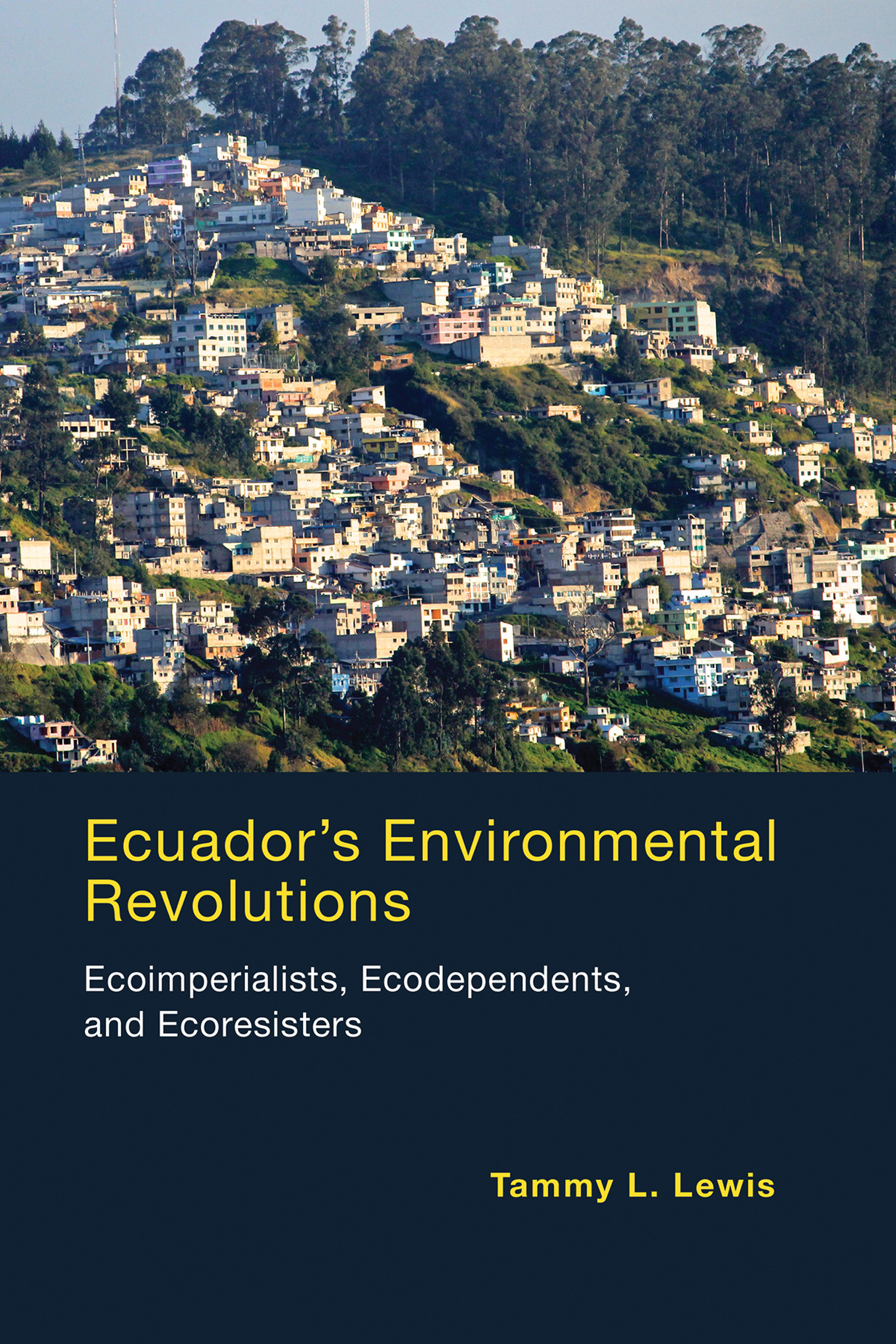
Ecuador's Environmental Revolutions An account of the movement for sustainable development in Ecuador through four eras: movement origins, neoliberal boom, neoliberal bust, and citizens' revolution. Ecuador is biologically diverse, petroleum rich, and economically poor. Its extraordinary biodiversity has attracted attention and funding from such transnational environmental organizations as Conservation International, the World Wildlife Fund, and the United States Agency for International Development. In Ecuador itself there are more than 200 environmental groups dedicated to sustainable development, and the country's 2008 constitution grants constitutional rights to nature. The current leftist government is committed both to lifting its people out of poverty and pursuing sustainable development, but petroleum extraction is Ecuador's leading source of revenue. While extraction generates economic growth, which supports the state's social welfare agenda, it also causes environmental destruction. Given these competing concerns, will Ecuador be able to achieve sustainability? In this book, Tammy Lewis examines the movement for sustainable development in Ecuador through four eras: movement origins (1978 to 1987), neoliberal boom (1987 to 2000), neoliberal bust (2000 to 2006), and citizens' revolution (2006 to 2015). Lewis presents a typology of Ecuador's environmental organizations: ecoimperialists, transnational environmentalists from other countries; ecodependents, national groups that partner with transnational groups; and ecoresisters, home-grown environmentalists who reject the dominant development paradigm. She examines the interplay of transnational funding, the Ecuadorian environmental movement, and the state's environmental and development policies. Along the way, addressing literatures in environmental sociology, social movements, and development studies, she explores what configuration of forces—political, economic, and environmental—is most likely to lead to a sustainable balance between the social system and the ecosystem. POLITICAL SCIENCE,Public Policy,Environmental Policy
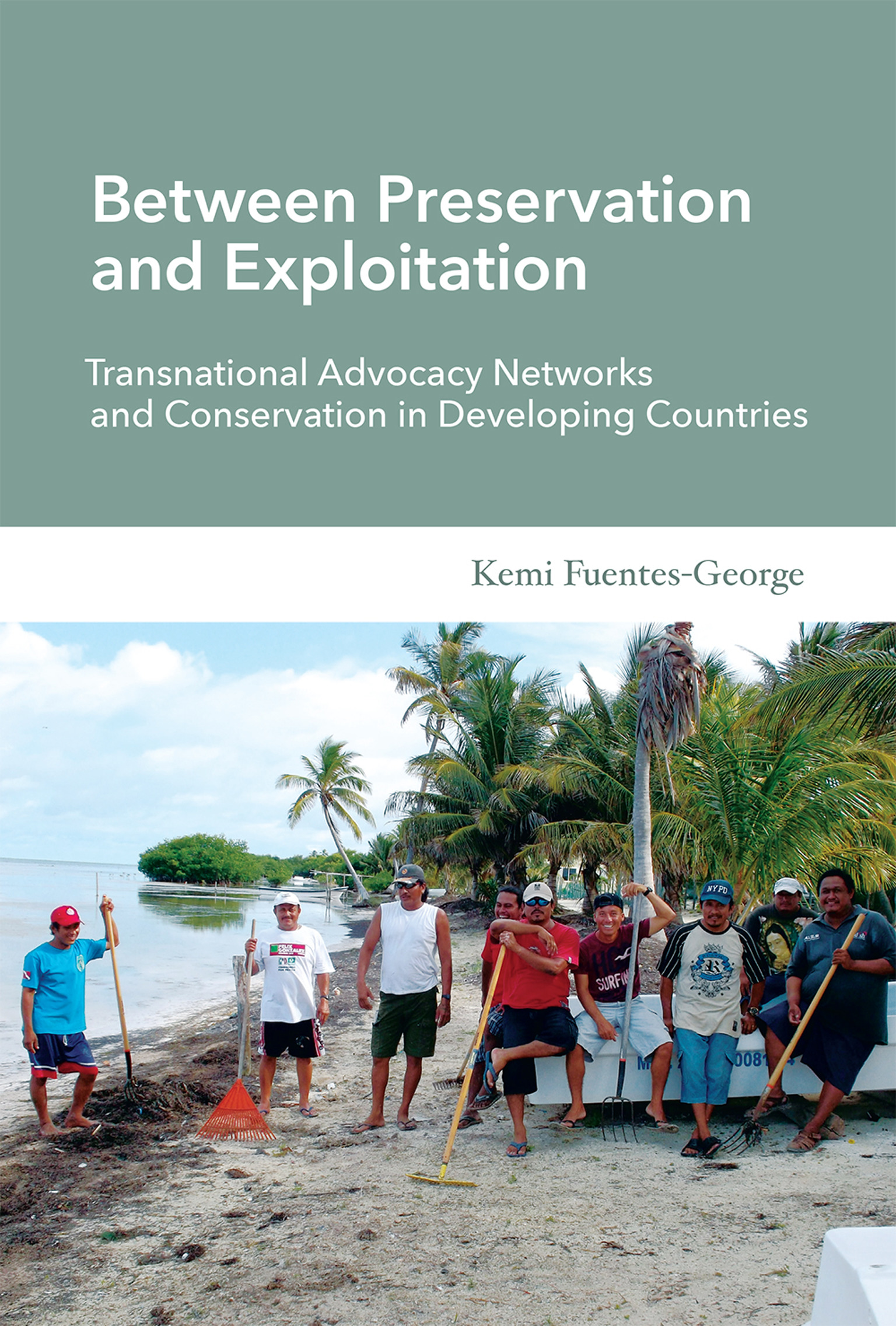
Between Preservation and Exploitation A study of biodiversity governance analyzes the factors that determine the effectiveness of transnational advocacy networks and the importance of justice claims to conservation. In the late 2000s, ordinary citizens in Jamaica and Mexico demanded that government put a stop to lucrative but environmentally harmful economic development activities—bauxite mining in Jamaica and large-scale tourism and overfishing on the eastern coast of the Yucatán Peninsula. In each case, the catalyst for the campaign was information gathered and disseminated by transnational advocacy networks (TANs) of researchers, academics, and activists. Both campaigns were successful despite opposition from industry supporters. Meanwhile, simultaneous campaigns to manage land in another part of the Yucatán and to conserve migratory birds in Egypt had far less success. In this book, Kemi Fuentes-George uses these four cases to analyze factors that determine the success or failure of efforts by TANs to persuade policymakers and private sector actors in developing countries to change environmental behavior. Fuentes-George argues that in order to influence the design and implementation of policy, TANs must generate a scientific consensus, create social relationships with local actors, and advocate for biodiversity in a way that promotes local environmental justice. Environmentally just policies would allow local populations access to their lands provided they use natural resources sustainably. Justice claims are also more likely to generate needed support among local groups for conservation projects. In their conservation efforts, Jamaica, Mexico, and Egypt were attempting to meet their obligations under the UN Convention on Biological Diversity and other regional agreements. Fuentes-George's innovative analysis shows the importance of local environmental justice for the implementation of international environmental treaties. POLITICAL SCIENCE,Public Policy,Environmental Policy

Dirty Gold The response from the jewelry industry to a campaign for ethically sourced gold as a case study in the power of business in global environmental politics. Gold mining can be a dirty business. It creates immense amounts of toxic materials that are difficult to dispose of. Mines are often developed without community consent, and working conditions for miners can be poor. Income from gold has funded wars. And consumers buy wedding rings and gold chains not knowing about any of this. In Dirty Gold, Michael Bloomfield shows what happened when Earthworks, a small Washington-based NGO, launched a campaign for ethically sourced gold in the consumer jewelry market, targeting Tiffany and other major firms. The unfolding of the campaign and its effect on the jewelry industry offer a lesson in the growing influence of business in global environmental politics. Earthworks planned a “shame” campaign, aimed at the companies' brands and reputations, betting that firms like Tiffany would not want to be associated with pollution, violence, and exploitation. As it happened, Tiffany contacted Earthworks before they could launch the campaign; the company was already looking for partners in finding ethically sourced gold. Bloomfield examines the responses of three companies to “No Dirty Gold” activism: Tiffany, Wal-Mart, and Brilliant Earth, a small company selling ethical jewelry. He finds they offer a case study in how firms respond to activist pressure and what happens when businesses participate in such private governance schemes as the “Golden Rules” and the “Conflict-Free Gold Standard.” Taking a firm-level view, Bloomfield examines the different opportunities for and constraints on corporate political mobilization within the industry. POLITICAL SCIENCE,Public Policy,Environmental Policy

Global Cities How Los Angeles, Hong Kong, and China deal with such urban environmental issues as ports, goods movement, air pollution, water quality, transportation, and public space. Over the past four decades, Los Angeles, Hong Kong, and key urban regions of China have emerged as global cities—in financial, political, cultural, environmental, and demographic terms. In this book, Robert Gottlieb and Simon Ng trace the global emergence of these urban areas and compare their responses to a set of six urban environmental issues. These cities have different patterns of development: Los Angeles has been the quintessential horizontal city, the capital of sprawl; Hong Kong is dense and vertical; China's new megacities in the Pearl River Delta, created by an explosion in industrial development and a vast migration from rural to urban areas, combine the vertical and the horizontal. All three have experienced major environmental changes in a relatively short period of time. Gottlieb and Ng document how each has dealt with challenges posed by ports and the movement of goods, air pollution (Los Angeles, Hong Kong, and urban China are all notorious for their hazardous air quality), water supply (all three places are dependent on massive transfers of water) and water quality, the food system (from seed to table), transportation, and public and private space. Finally they discuss the possibility of change brought about by policy initiatives and social movements. POLITICAL SCIENCE,Public Policy,Environmental Policy
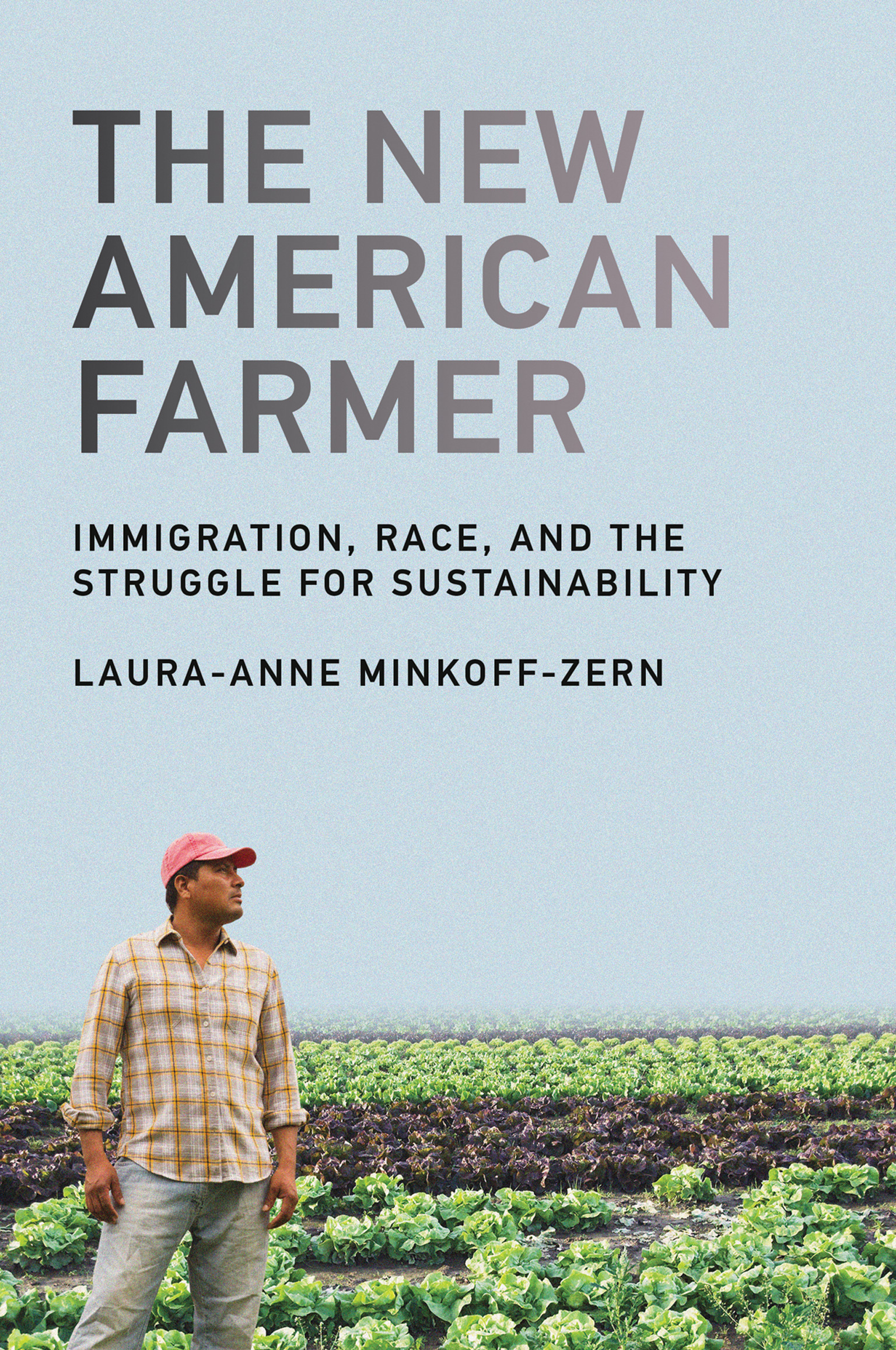
The New American Farmer An examination of Latino/a immigrant farmers as they transition from farmworkers to farm owners that offers a new perspective on racial inequity and sustainable farming. Although the majority of farms in the United States have US-born owners who identify as white, a growing number of new farmers are immigrants, many of them from Mexico, who originally came to the United States looking for work in agriculture. In The New American Farmer, Laura-Anne Minkoff-Zern explores the experiences of Latino/a immigrant farmers as they transition from farmworkers to farm owners, offering a new perspective on racial inequity and sustainable farming. She finds that many of these new farmers rely on farming practices from their home countries—including growing multiple crops simultaneously, using integrated pest management, maintaining small-scale production, and employing family labor—most of which are considered alternative farming techniques in the United States. Drawing on extensive interviews with farmers and organizers, Minkoff-Zern describes the social, economic, and political barriers immigrant farmers must overcome, from navigating USDA bureaucracy to racialized exclusion from opportunities. She discusses, among other topics, the history of discrimination against farm laborers in the United States; the invisibility of Latino/a farmers to government and universities; new farmers' sense of agrarian and racial identity; and the future of the agrarian class system. Minkoff-Zern argues that immigrant farmers, with their knowledge and experience of alternative farming practices, are—despite a range of challenges—actively and substantially contributing to the movement for an ecological and sustainable food system. Scholars and food activists should take notice. POLITICAL SCIENCE,Public Policy,Environmental Policy

Greening through Trade How the environmental provisions in US preferential trade agreements affect both the environmental policies of trading partners and the effectiveness of multilateral environmental agreements. As trade negotiations within the World Trade Organization seem permanently stalled, countries turn increasingly to preferential trade agreements (PTAs) between smaller groups of nations. Many of these PTAs incorporate environmental provisions, some of which require trading partners to enact new domestic environmental laws, and use the enforcement mechanisms available within trade agreements as tools for environmental protection. In Greening through Trade, Sikina Jinnah and Jean-Frédéric Morin provide the first detailed examination of how the environmental provisions in US preferential trade agreements affect both the environmental policies of trading partners and the effectiveness of multilateral environmental agreements. They do so through a combination of in-depth qualitative case studies and quantitative analysis of an original dataset of 688 global PTAs. Jinnah and Morin explore the effects of linkages between PTAs and environmental treaties and the diffusion of environmental norms and policy through PTAs. Centrally, they argue that US trade agreements can serve as mechanisms both to export environmental policies to trading partner nations and third-party countries and to enhance the effectiveness of multilateral environmental agreements by strengthening their enforcement capacity. They caution that PTAs are not a panacea for environmental governance; deeper problems of unsustainable consumption and differential power dynamics between trading partners must be carefully navigated in deploying trade agreements for environmental protection. POLITICAL SCIENCE,Public Policy,Environmental Policy
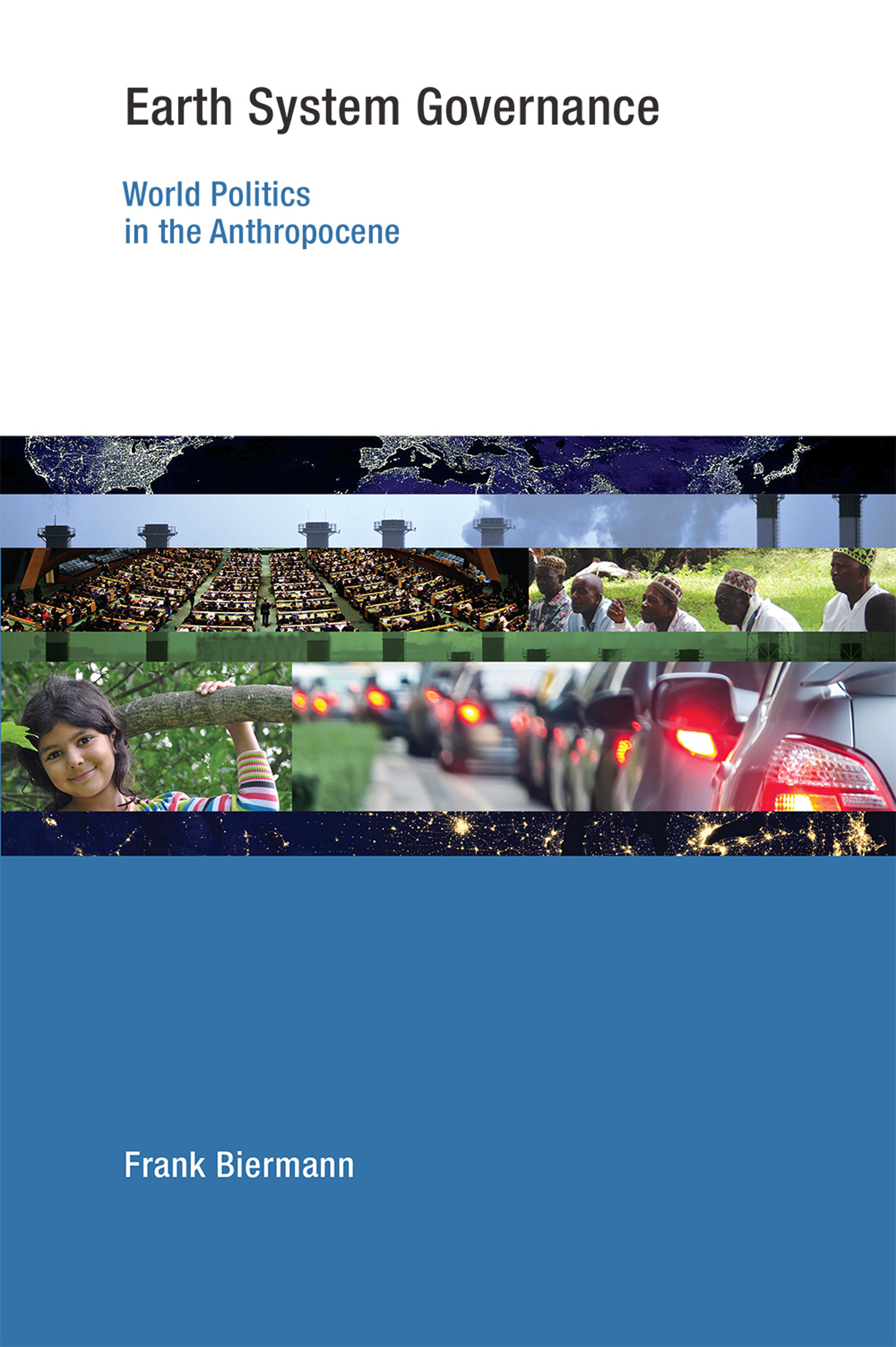
Earth System Governance A new model for effective global environmental governance in an era of human-caused planetary transformation and disruption. Humans are no longer spectators who need to adapt to their natural environment. Our impact on the earth has caused changes that are outside the range of natural variability and are equivalent to such major geological disruptions as ice ages. Some scientists argue that we have entered a new epoch in planetary history: the Anthropocene. In such an era of planet-wide transformation, we need a new model for planet-wide environmental politics. In this book, Frank Biermann proposes “earth system” governance as just such a new paradigm. Biermann offers both analytical and normative perspectives. He provides detailed analysis of global environmental politics in terms of five dimensions of effective governance: agency, particularly agency beyond that of state actors; architecture of governance, from local to global levels; accountability and legitimacy; equitable allocation of resources; and adaptiveness of governance systems. Biermann goes on to offer a wide range of policy proposals for future environmental governance and a revitalized United Nations, including the establishment of a World Environment Organization and a UN Sustainable Development Council, new mechanisms for strengthened representation of civil society and scientists in global decision making, innovative systems of qualified majority voting in multilateral negotiations, and novel institutions to protect those impacted by global change. Drawing on ten years of research, Biermann formulates earth system governance as an empirical reality and a political necessity. POLITICAL SCIENCE,Public Policy,Environmental Policy
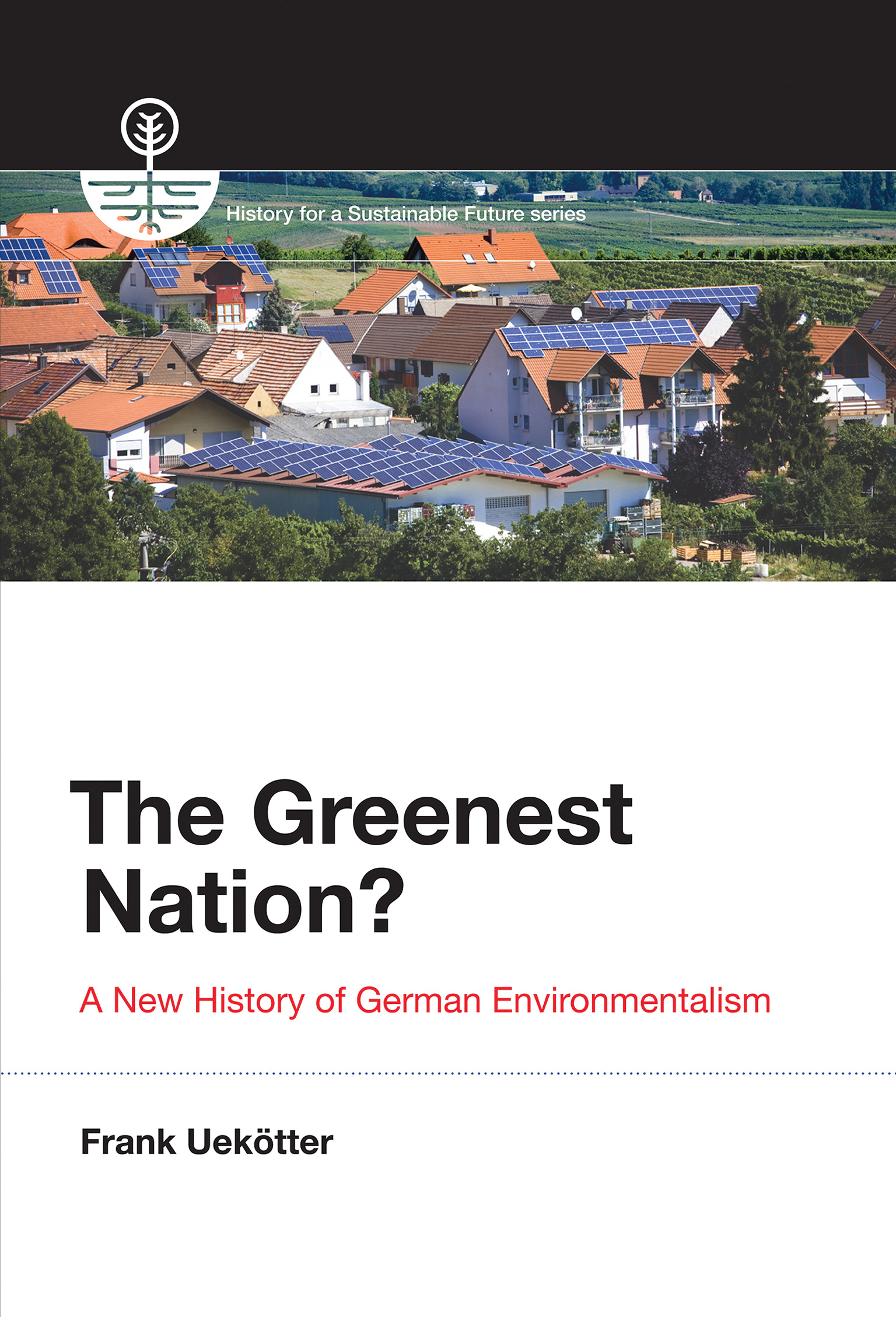
The Greenest Nation? An account of German environmentalism that shows the influence of the past on today's environmental decisions. Germany enjoys an enviably green reputation. Environmentalists in other countries applaud its strict environmental laws, its world-class green technology firms, its phase-out of nuclear power, and its influential Green Party. Germans are proud of these achievements, and environmentalism has become part of the German national identity. In The Greenest Nation? Frank Uekötter offers an overview of the evolution of German environmentalism since the late nineteenth century. He discusses, among other things, early efforts at nature protection and urban sanitation, the Nazi experience, and civic mobilization in the postwar years. He shows that much of Germany's green reputation rests on accomplishments of the 1980s, and emphasizes the mutually supportive roles of environmental nongovernmental organizations, corporations, and the state. Uekötter looks at environmentalism in terms of civic activism, government policy, and culture and life, eschewing the usual focus on politics, prophets, and NGOs. He also views German environmentalism in an international context, tracing transnational networks of environmental issues and actions and discussing German achievements in relation to global trends. Bringing his discussion up to the present, he shows the influence of the past on today's environmental decisions. As environmentalism is wrestling with the challenges of the twenty-first century, Germany could provide a laboratory for the rest of the world. POLITICAL SCIENCE,Public Policy,Environmental Policy
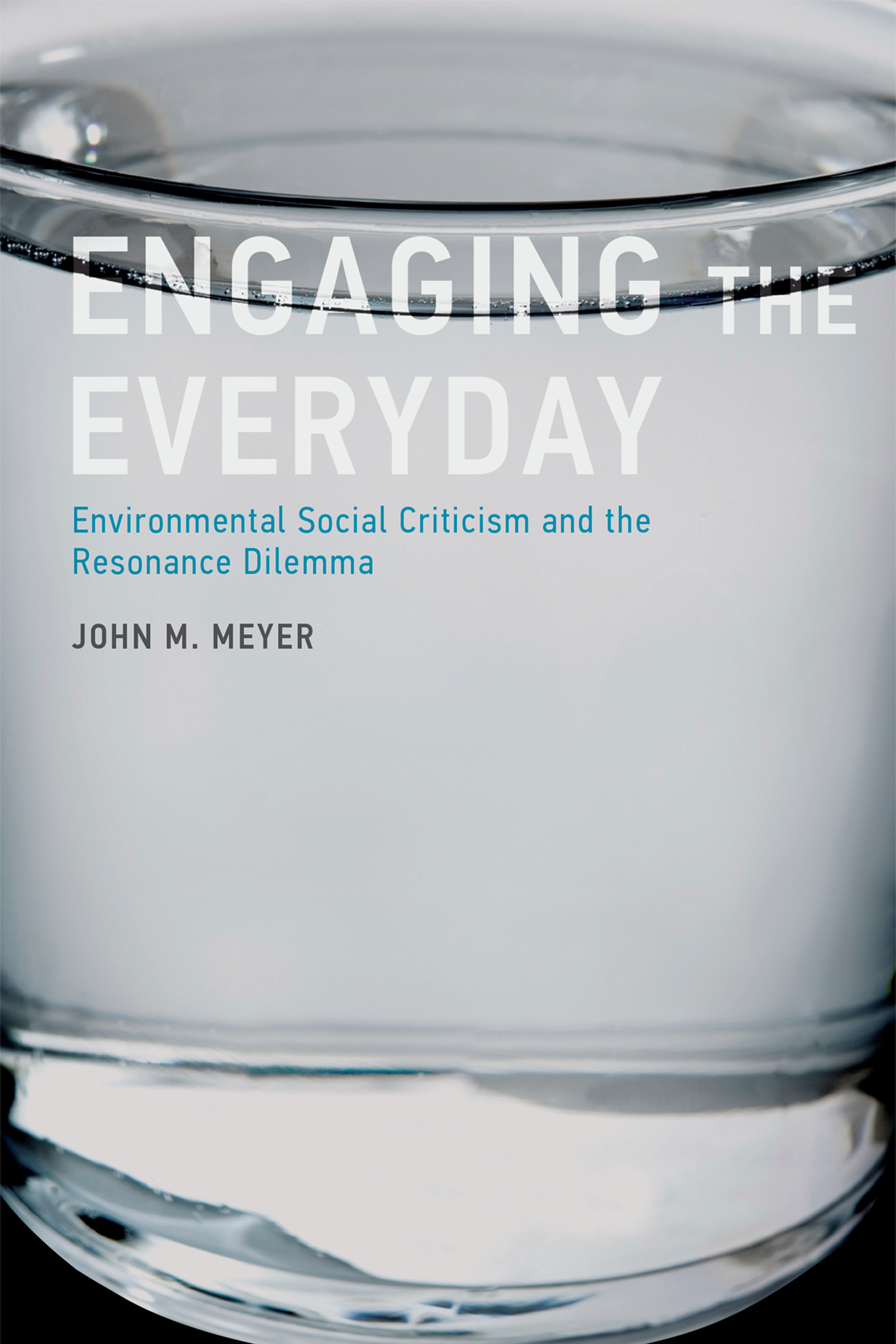
Engaging the Everyday An argument that environmental challenges will only resonate with citizens of affluent postindustrial countries if sustainability concerns emerge from everyday practices. Far-reaching efforts to address environmental issues rarely seem to resonate with citizens of the United States or other wealthy postindustrial societies. In Engaging the Everyday, John Meyer considers this impediment to action on environmental problems—which he terms “the resonance dilemma”—and argues that an environmental agenda that emerges from everyday concerns would resonate more deeply with ordinary citizens. Meyer explores the contours of this alternative, theorizing both obstacles and opportunities and then considering it in terms of three everyday areas of material practice: land use, transportation by automobile, and home dwelling. Adopting the stance of an “inside critic” (neither detached theorist nor narrow policy advocate), and taking an approach that he calls “contested materiality,” Meyer draws on a variety of theoretical perspectives to construct a framework for understanding material practices. He reimagines each of the three material practices in terms of a political idea: for land, property; for automobiles, freedom; and for homes, citizenship. His innovative analysis offers a grounded basis for reshaping our talk about political concepts and values. POLITICAL SCIENCE,Public Policy,Environmental Policy
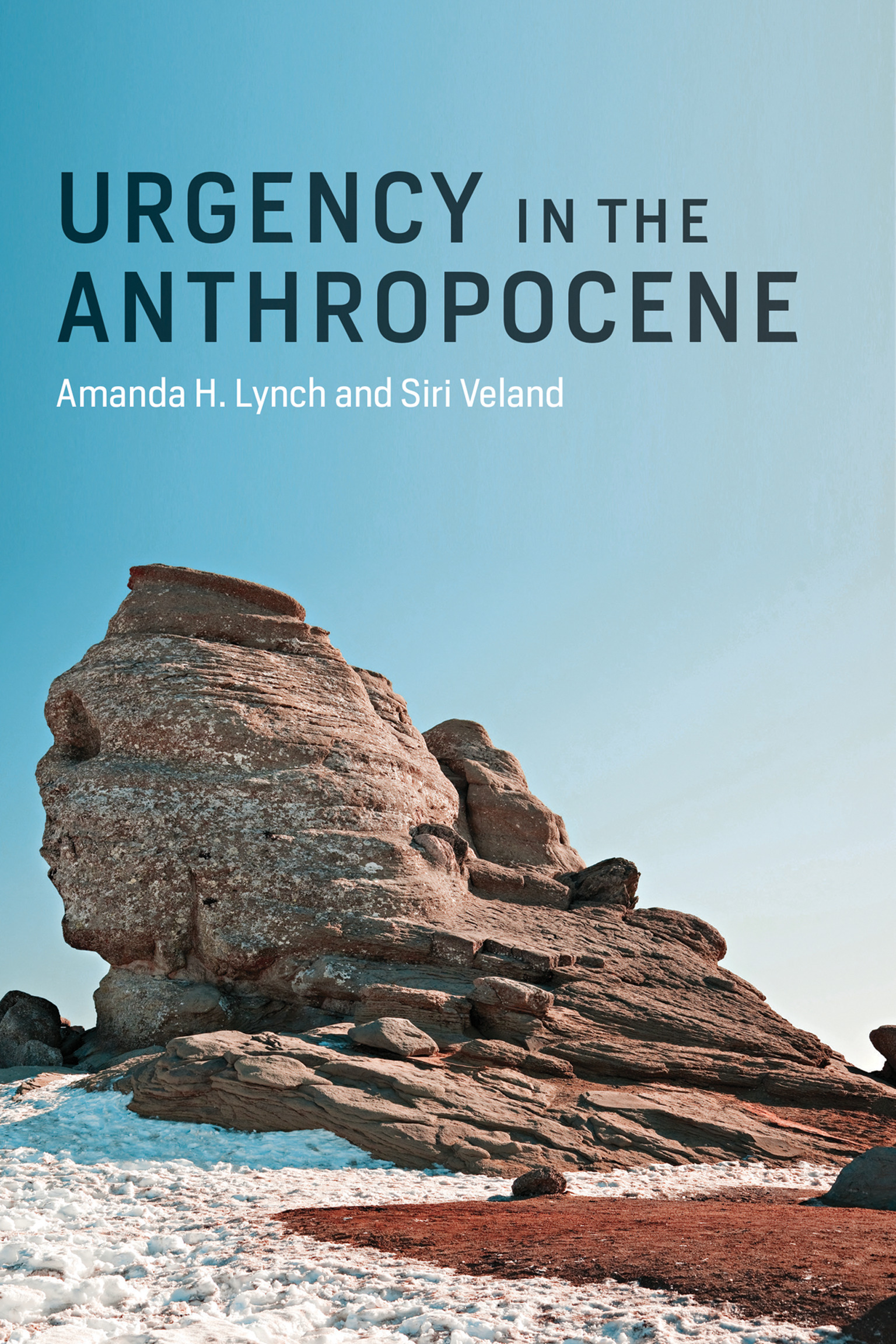
Urgency in the Anthropocene A proposal to reframe the Anthropocene as an age of actual and emerging coexistence with earth system variability, encompassing both human dignity and environmental sustainability. Is this the Anthropocene, the age in which humans have become a geological force, leaving indelible signs of their activities on the earth? The narrative of the Anthropocene so far is characterized by extremes, emergencies, and exceptions—a tale of apocalypse by our own hands. The sense of ongoing crisis emboldens policy and governance responses that challenge established systems of sovereignty and law. The once unacceptable—geoengineering technology, for example, or authoritarian decision making—are now anticipated and even demanded by some. To counter this, Amanda Lynch and Siri Veland propose a reframing of the Anthropocene—seeing it not as a race against catastrophe but as an age of emerging coexistence with earth system variability. Lynch and Veland examine the interplay between our new state of ostensible urgency and the means by which this urgency is identified and addressed. They examine how societies, including Indigenous societies, have understood such interplays; explore how extreme weather and climate weave into the Anthropocene narrative; consider the tension between the short time scale of disasters and the longer time scale of sustainability; and discuss both international and national approaches to Anthropocene governance. Finally, they argue for an Anthropocene of coexistence that embraces both human dignity and sustainability. POLITICAL SCIENCE,Public Policy,Environmental Policy
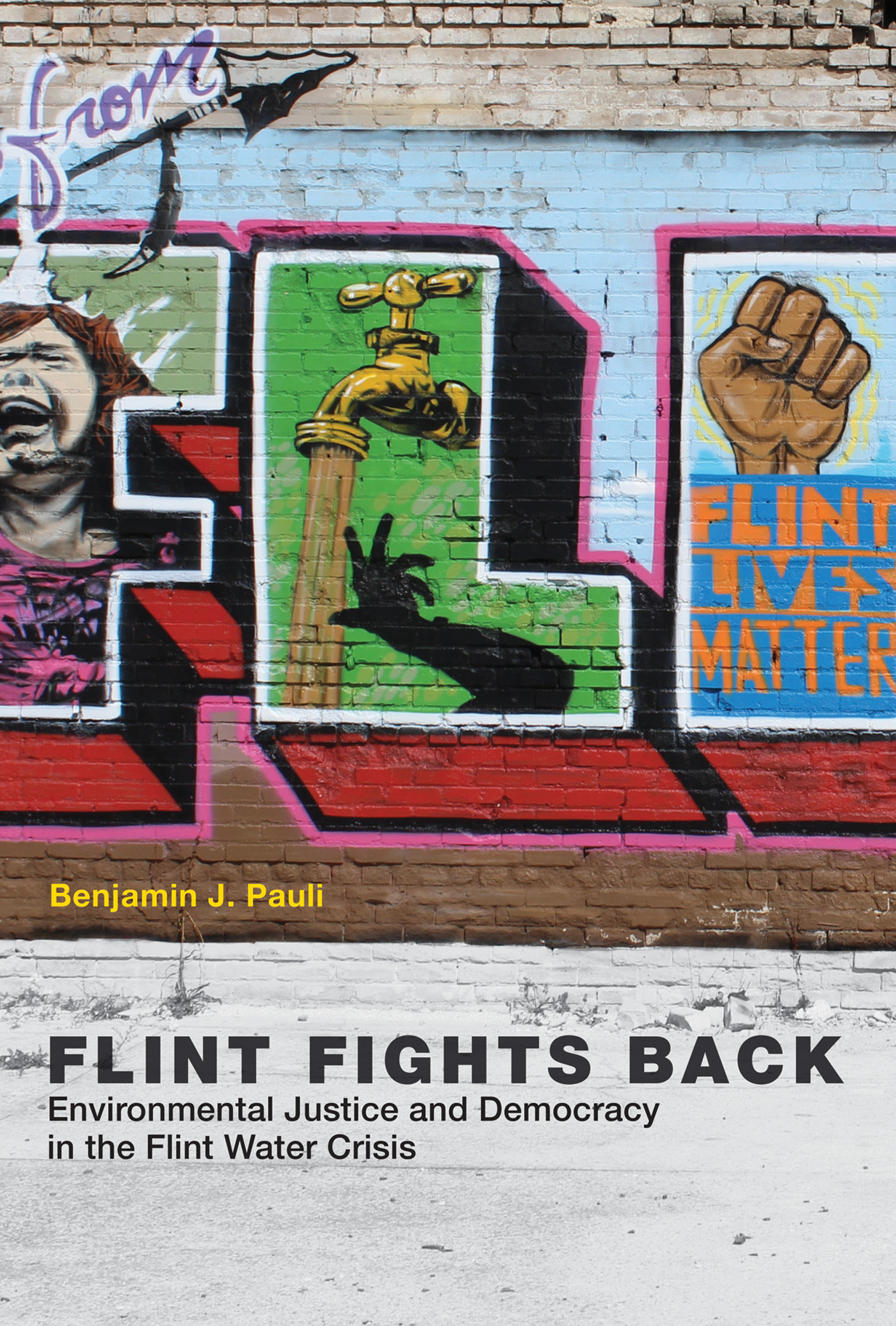
Flint Fights Back An account of the Flint water crisis shows that Flint's struggle for safe and affordable water is part of a broader struggle for democracy. When Flint, Michigan, changed its source of municipal water from Lake Huron to the Flint River, Flint residents were repeatedly assured that the water was of the highest quality. At the switchover ceremony, the mayor and other officials performed a celebratory toast, declaring “Here's to Flint!” and downing glasses of freshly treated water. But as we now know, the water coming out of residents' taps harbored a variety of contaminants, including high levels of lead. In Flint Fights Back, Benjamin Pauli examines the water crisis and the political activism that it inspired, arguing that Flint's struggle for safe and affordable water was part of a broader struggle for democracy. Pauli connects Flint's water activism with the ongoing movement protesting the state of Michigan's policy of replacing elected officials in financially troubled cities like Flint and Detroit with appointed “emergency managers.” Pauli distinguishes the political narrative of the water crisis from the historical and technical narratives, showing that Flint activists' emphasis on democracy helped them to overcome some of the limitations of standard environmental justice frameworks. He discusses the pro-democracy (anti–emergency manager) movement and traces the rise of the “water warriors”; describes the uncompromising activist culture that developed out of the experience of being dismissed and disparaged by officials; and examines the interplay of activism and scientific expertise. Finally, he explores efforts by activists to expand the struggle for water justice and to organize newly mobilized residents into a movement for a radically democratic Flint. POLITICAL SCIENCE,Public Policy,Environmental Policy
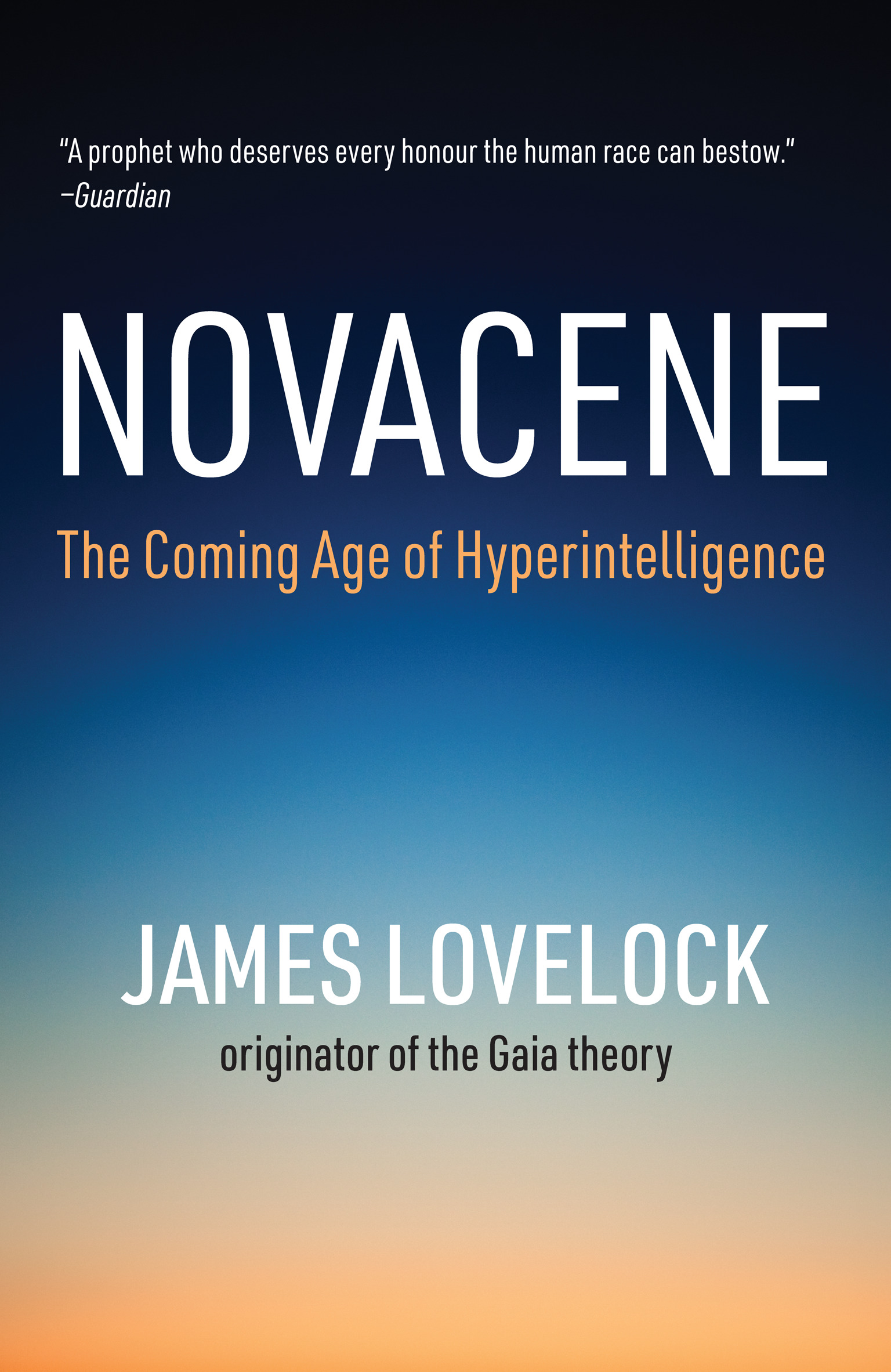
Novacene The originator of the Gaia theory offers the vision of a future epoch in which humans and artificial intelligence together will help the Earth survive. James Lovelock, creator of the Gaia hypothesis and the greatest environmental thinker of our time, has produced an astounding new theory about future of life on Earth. He argues that the Anthropocene—the age in which humans acquired planetary-scale technologies—is, after 300 years, coming to an end. A new age—the Novacene—has already begun. In the Novacene, new beings will emerge from existing artificial intelligence systems. They will think 10,000 times faster than we do and they will regard us as we now regard plants. But this will not be the cruel, violent machine takeover of the planet imagined by science fiction. These hyperintelligent beings will be as dependent on the health of the planet as we are. They will need the planetary cooling system of Gaia to defend them from the increasing heat of the sun as much as we do. And Gaia depends on organic life. We will be partners in this project. It is crucial, Lovelock argues, that the intelligence of Earth survives and prospers. He does not think there are intelligent aliens, so we are the only beings capable of understanding the cosmos. Perhaps, he speculates, the Novacene could even be the beginning of a process that will finally lead to intelligence suffusing the entire cosmos. At the age of 100, James Lovelock has produced the most important and compelling work of his life. POLITICAL SCIENCE,Public Policy,Environmental Policy
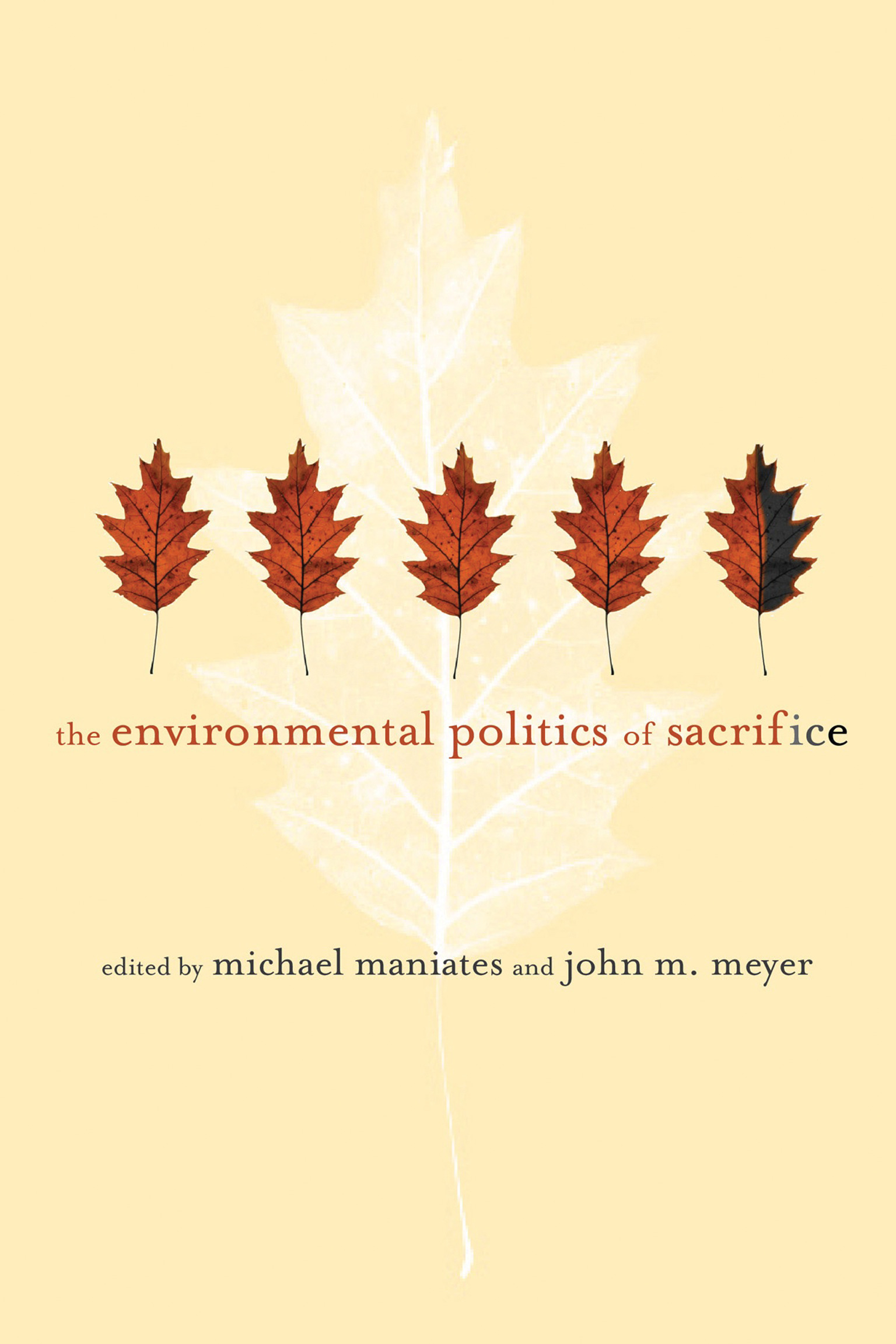
The Environmental Politics of Sacrifice An argument that the idea of sacrifice, with all its political baggage, opens new paths to environmental sustainability. The idea of sacrifice is the unspoken issue of environmental politics. Politicians, the media, and many environmentalists assume that well-off populations won't make sacrifices now for future environmental benefits and won't change their patterns and perceptions of consumption to make ecological room for the world's three billion or so poor eager to improve their standard of living. The Environmental Politics of Sacrifice challenges these assumptions, arguing that they limit our policy options, weaken our ability to imagine bold action for change, and blind us to the ways sacrifice already figures in everyday life. The concept of sacrifice has been curiously unexamined in both activist and academic conversations about environmental politics, and this book is the first to confront it directly. The chapters bring a variety of disciplinary perspectives to the topic. Contributors offer alternatives to the conventional wisdom on sacrifice; identify connections between sacrifice and human fulfillment in everyday life, finding such concrete examples as parents' sacrifices in raising children, religious practice, artists' pursuit of their art, and soldiers and policemen who risk their lives to do their jobs; and examine particular policies and practices that shape our understanding of environmental problems, including the carbon tax, incentives for cyclists, and the perils of green consumption. The Environmental Politics of Sacrifice puts “sacrifice” firmly into the conversation about effective environmental politics and policies, insisting that activists and scholars do more than change the subject when the idea is introduced. Contributors Peter Cannavò, Shane Gunster, Cheryl Hall, Karen Litfin, Michael Maniates, John M. Meyer, Simon Nicholson, Anna Peterson, Thomas Princen, Sudhir Chella Rajan, Paul Wapner, Justin Williams POLITICAL SCIENCE,Public Policy,Environmental Policy

Recycling Reconsidered How the success and popularity of recycling has diverted attention from the steep environmental costs of manufacturing the goods we consume and discard. Recycling is widely celebrated as an environmental success story. The accomplishments of the recycling movement can be seen in municipal practice, a thriving private recycling industry, and widespread public support and participation. In the United States, more people recycle than vote. But, as Samantha MacBride points out in this book, the goals of recycling—saving the earth (and trees), conserving resources, and greening the economy—are still far from being realized. The vast majority of solid wastes are still burned or buried. MacBride argues that, since the emergence of the recycling movement in 1970, manufacturers of products that end up in waste have successfully prevented the implementation of more onerous, yet far more effective, forms of sustainable waste policy. Recycling as we know it today generates the illusion of progress while allowing industry to maintain the status quo and place responsibility on consumers and local government. MacBride offers a series of case studies in recycling that pose provocative questions about whether the current ways we deal with waste are really the best ways to bring about real sustainability and environmental justice. She does not aim to debunk or discourage recycling but to help us think beyond recycling as it is today. POLITICAL SCIENCE,Public Policy,Environmental Policy

The Future Is Not What It Used to Be A hard look at the twin challenges of climate change and energy scarcity that examines historical precedents and allows no room for complacency. The future is not what it used to be because we can no longer rely on the comforting assumption that it will resemble the past. Past abundance of fuel, for example, does not imply unending abundance. Infinite growth on a finite planet is not possible. In this book, Jörg Friedrichs argues that industrial society itself is transitory, and he examines the prospects for our civilization's coming to terms with its two most imminent choke points: climate change and energy scarcity. He offers a thorough and accessible account of these two challenges as well as the linkages between them. Friedrichs contends that industrial civilization cannot outlast our ability to burn fossil fuels and that the demise of industrial society would entail cataclysmic change, including population decreases. To understand the social and political implications, he examines historical cases of climate stress and energy scarcity: devastating droughts in the ancient Near East; the Little Ice Age in the medieval Far North; the Japanese struggle to prevent “fuel starvation” from 1918 to 1945; the “totalitarian retrenchment” of the North Korean governing class after the end of Soviet oil deliveries; and Cuba's socioeconomic adaptation to fuel scarcity in the 1990s. He draws important lessons about the likely effects of climate and energy disruptions on different kinds of societies. The warnings of climate scientists are met by denial and inaction, while energy experts offer little guidance on the effects of future scarcity. Friedrichs suggests that to confront our predicament we must affirm our core values and take action to transform our way of life. Whether we are private citizens or public officials, complacency is not an option: climate change and energy scarcity are emerging facts of life. POLITICAL SCIENCE,Public Policy,Environmental Policy

Oil, Illiberalism, and War An argument that America's addiction to crude oil has driven a foreign policy of intervention and exploitation hidden behind a facade of liberal internationalism. The United States is addicted to crude oil. In this book, Andrew Price-Smith argues that this addiction has distorted the conduct of American foreign policy in profound and malign ways, resulting in interventionism, exploitation, and other illiberal behaviors that hide behind a facade of liberal internationalism. The symbiotic relationship between the state and the oil industry has produced deviations from rational foreign energy policy, including interventions in Iraq and elsewhere that have been (at the very least) counterproductive or (at worst) completely antithetical to national interests. Liberal internationalism casts the United States as a benign hegemon, guaranteeing security to its allies during the Cold War and helping to establish collaborative international institutions. Price-Smith argues for a reformulation of liberal internationalism (which he terms shadow liberalism) that takes into account the dark side of American foreign policy. Price-Smith contends that the “free market” in international oil is largely a myth, rendered problematic by energy statism and the rise of national oil companies. He illustrates the destabilizing effect of oil in the Persian Gulf, and describes the United States' grand energy strategy, particularly in the Persian Gulf, as illiberal at its core, focused on the projection of power and on periodic bouts of violence. Washington's perennial oscillation between liberal phases of institution building and provision of public goods and illiberal bellicosity, Price-Smith argues, represents the shadow liberalism that is at the core of US foreign policy. POLITICAL SCIENCE,Public Policy,Environmental Policy
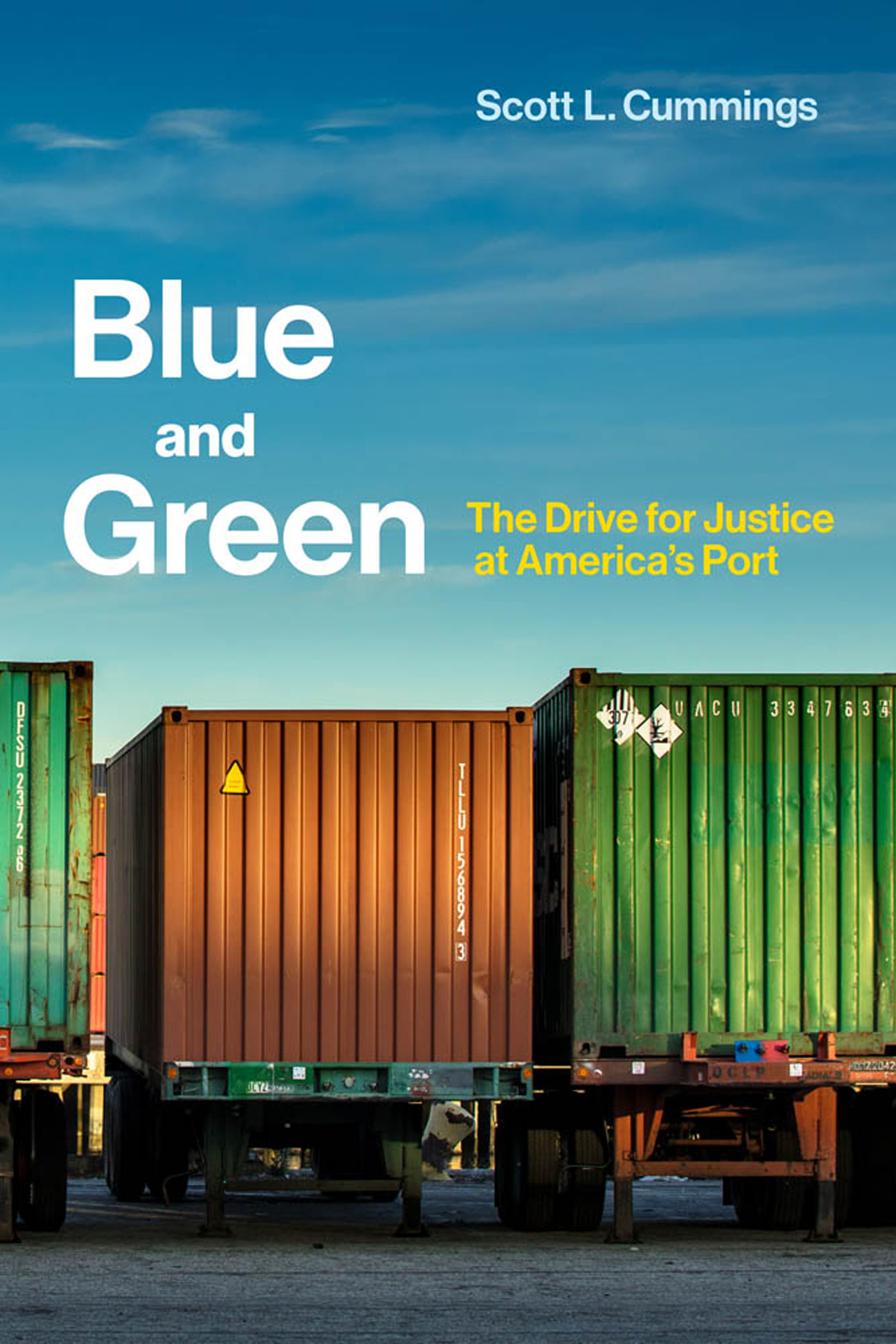
Blue and Green How an alliance of the labor and environmental movements used law as a tool to clean up the trucking industry at the nation's largest port. In Blue and Green, Scott Cummings examines a campaign by the labor and environmental movements to transform trucking at America's largest port in Los Angeles. Tracing the history of struggle in an industry at the epicenter of the global supply chain, Cummings shows how an unprecedented “blue-green” alliance mobilized to improve working conditions for low-income drivers and air quality in nearby communities. The campaign for “clean trucks,” Cummings argues, teaches much about how social movements can use law to challenge inequality in a global era. Cummings shows how federal deregulation created interrelated economic and environmental problems at the port and how the campaign fought back by mobilizing law at the local level. He documents three critical stages: initial success in passing landmark legislation requiring port trucking companies to convert trucks from dirty to clean and drivers from contractors to employees with full labor rights; campaign decline after industry litigation blocked employee conversion; and campaign resurgence through an innovative legal approach to driver misclassification that realized a central labor movement goal—unionizing port truckers. Appraising the campaign, Cummings analyzes the tradeoffs of using alternative legal frameworks to promote labor organizing, and explores lessons for building movements to regulate low-wage work in the “gig” economy. He shows how law can bind coalitions together and split them apart, and concludes that the fight for legal reform never ends, but rather takes different turns on the long road to justice. POLITICAL SCIENCE,Public Policy,Environmental Policy
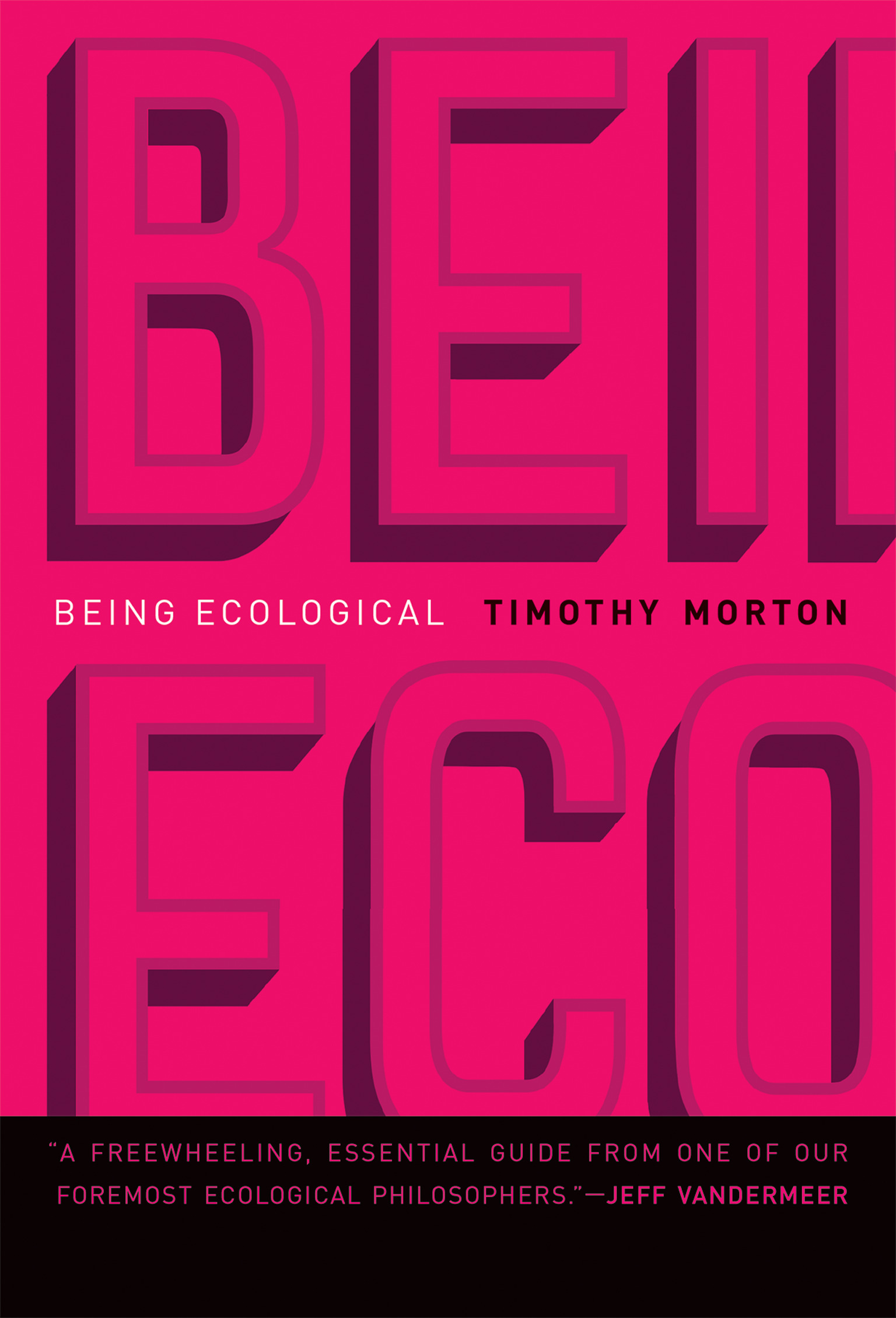
Being Ecological A book about ecology without information dumping, guilt inducing, or preaching to the choir. Don't care about ecology? You think you don't, but you might all the same. Don't read ecology books? This book is for you. Ecology books can be confusing information dumps that are out of date by the time they hit you. Slapping you upside the head to make you feel bad. Grabbing you by the lapels while yelling disturbing facts. Handwringing in agony about “What are we going to do?” This book has none of that. Being Ecological doesn't preach to the eco-choir. It's for you—even, Timothy Morton explains, if you're not in the choir, even if you have no idea what choirs are. You might already be ecological. After establishing the approach of the book (no facts allowed!), Morton draws on Kant and Heidegger to help us understand living in an age of mass extinction caused by global warming. He considers the object of ecological awareness and ecological thinking: the biosphere and its interconnections. He discusses what sorts of actions count as ecological—starting a revolution? going to the garden center to smell the plants? And finally, in “Not a Grand Tour of Ecological Thought,” he explores a variety of current styles of being ecological—a range of overlapping orientations rather than preformatted self-labeling. Caught up in the us-versus-them (or you-versus-everything else) urgency of ecological crisis, Morton suggests, it's easy to forget that you are a symbiotic being entangled with other symbiotic beings. Isn't that being ecological? POLITICAL SCIENCE,Public Policy,Environmental Policy
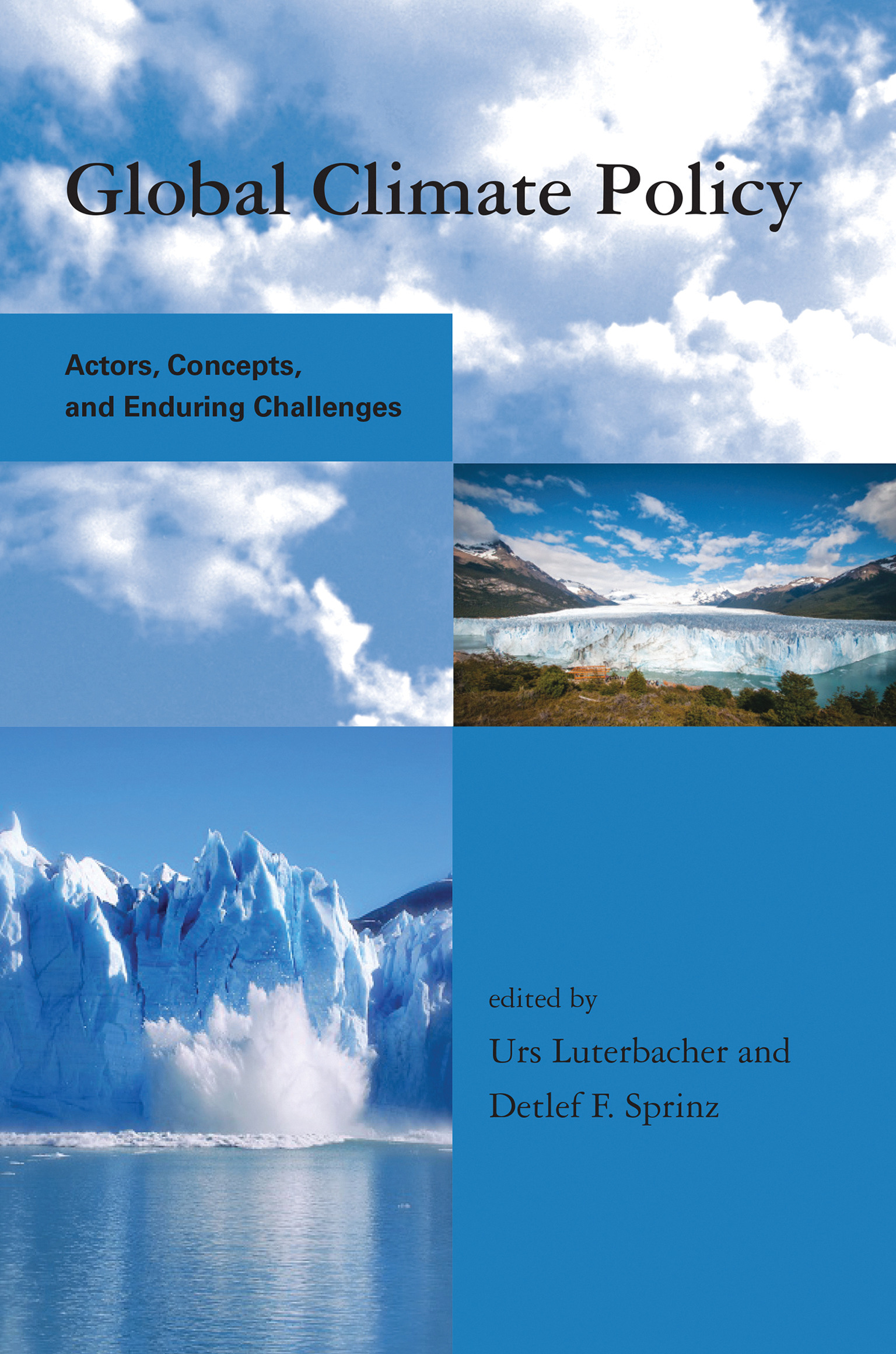
Global Climate Policy Analyses of the international climate change regime consider the challenges of maintaining current structures and the possibilities for creating new forms of international cooperation. The current international climate change regime has a long history, and it is likely that its evolution will continue, despite such recent setbacks as the decision by President Donald Trump to withdraw the United States from the Paris Agreement of 2015. Indeed, the U.S. withdrawal may spur efforts by other members of the international community to strengthen the Paris accord on their own. This volume offers an original contribution to the study of the international political context of climate change over the last three decades, with fresh analyses of the current international climate change regime that consider both the challenges of maintaining current structures and the possibilities for creating new forms of international cooperation. The contributors are leading experts with both academic and policy experience; some are advisors to governments and the Climate Secretariat itself. Their contributions combine substantive evidence with methodological rigor. They discuss such topics as the evolution of the architecture of the climate change regime; different theoretical perspectives; game-theoretical and computer simulation approaches to modeling outcomes and assessing agreements; coordination with other legal regimes; non-state actors; developing and emerging countries; implementation, compliance, and effectiveness of agreements; and the challenges of climate change mitigation after the Paris Agreement. Contributors Michaël Aklin, Guri Bang, Daniel Bodansky, Thierry Bréchet, Lars Brückner, Frank Grundig, Jon Hovi, Yasuko Kameyama, Urs Luterbacher, Axel Michaelowa, Katharina Michaelowa, Carla Norrlof, Matthew Paterson, Lavanya Rajamani, Tora Skodvin, Detlef F. Sprinz, Arild Underdal, Jorge E. Viñuales, Hugh Ward POLITICAL SCIENCE,Public Policy,Environmental Policy
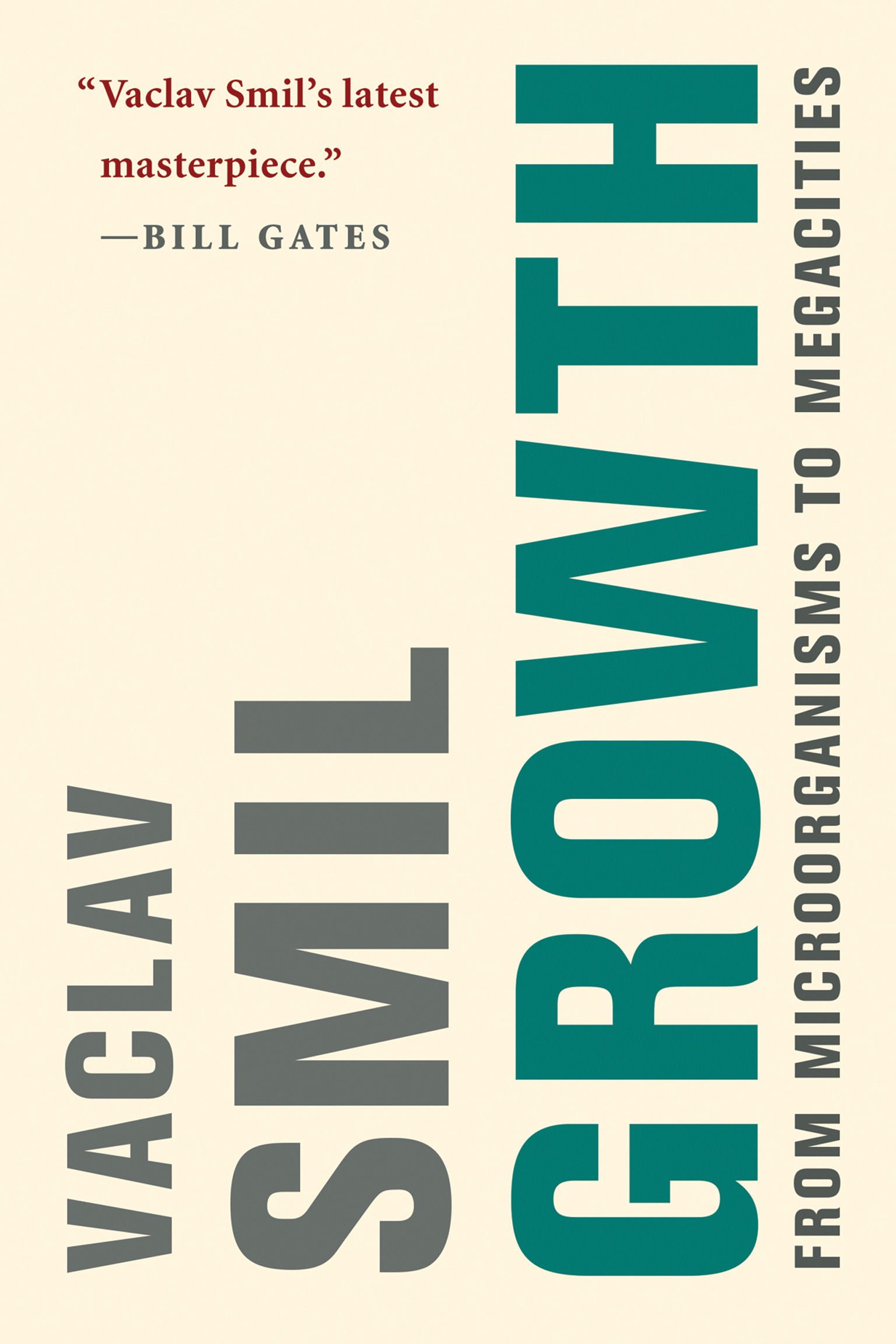
Growth A systematic investigation of growth in nature and society, from tiny organisms to the trajectories of empires and civilizations. Growth has been both an unspoken and an explicit aim of our individual and collective striving. It governs the lives of microorganisms and galaxies; it shapes the capabilities of our extraordinarily large brains and the fortunes of our economies. Growth is manifested in annual increments of continental crust, a rising gross domestic product, a child's growth chart, the spread of cancerous cells. In this magisterial book, Vaclav Smil offers systematic investigation of growth in nature and society, from tiny organisms to the trajectories of empires and civilizations. Smil takes readers from bacterial invasions through animal metabolisms to megacities and the global economy. He begins with organisms whose mature sizes range from microscopic to enormous, looking at disease-causing microbes, the cultivation of staple crops, and human growth from infancy to adulthood. He examines the growth of energy conversions and man-made objects that enable economic activities—developments that have been essential to civilization. Finally, he looks at growth in complex systems, beginning with the growth of human populations and proceeding to the growth of cities. He considers the challenges of tracing the growth of empires and civilizations, explaining that we can chart the growth of organisms across individual and evolutionary time, but that the progress of societies and economies, not so linear, encompasses both decline and renewal. The trajectory of modern civilization, driven by competing imperatives of material growth and biospheric limits, Smil tells us, remains uncertain. POLITICAL SCIENCE,Public Policy,Environmental Policy
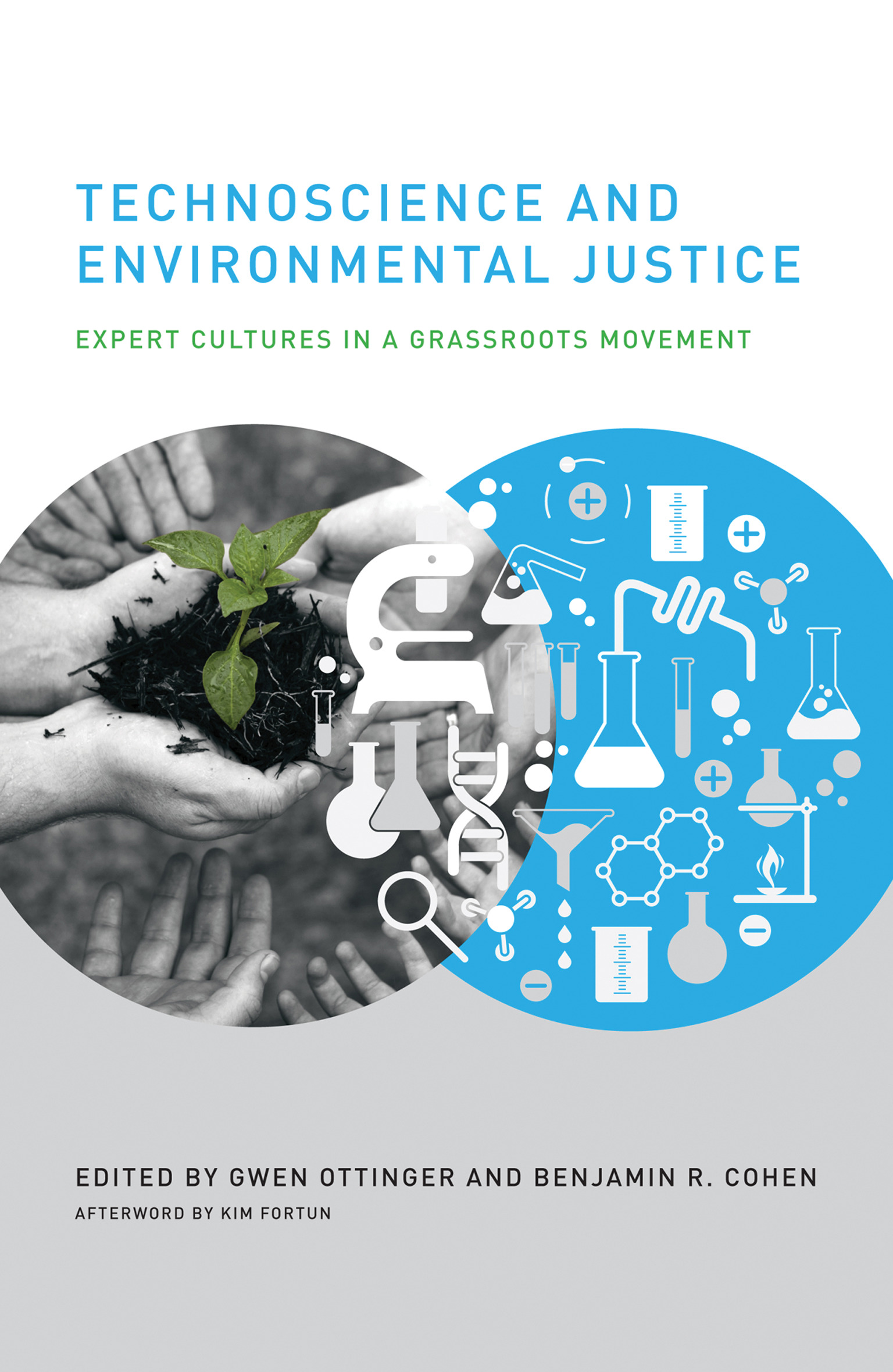
Technoscience and Environmental Justice Case studies exploring how experts' encounters with environmental justice are changing technical and scientific practice. Over the course of nearly thirty years, the environmental justice movement has changed the politics of environmental activism and influenced environmental policy. In the process, it has turned the attention of environmental activists and regulatory agencies to issues of pollution, toxics, and human health as they affect ordinary people, especially people of color. This book argues that the environmental justice movement has also begun to transform science and engineering. The chapters present case studies of technical experts' encounters with environmental justice activists and issues, exploring the transformative potential of these interactions. Technoscience and Environmental Justice first examines the scientific practices and identities of technical experts who work with environmental justice organizations, whether by becoming activists themselves or by sharing scientific information with communities. It then explore scientists' and engineers' activities in such mainstream scientific institutions as regulatory agencies and universities, where environmental justice concerns have been (partially) institutionalized as a response to environmental justice activism. All of the chapters grapple with the difficulty of transformation that experts face, but the studies also show how environmental justice activism has created opportunities for changing technical practices and, in a few cases, has even accomplished significant transformations. POLITICAL SCIENCE,Public Policy,Environmental Policy
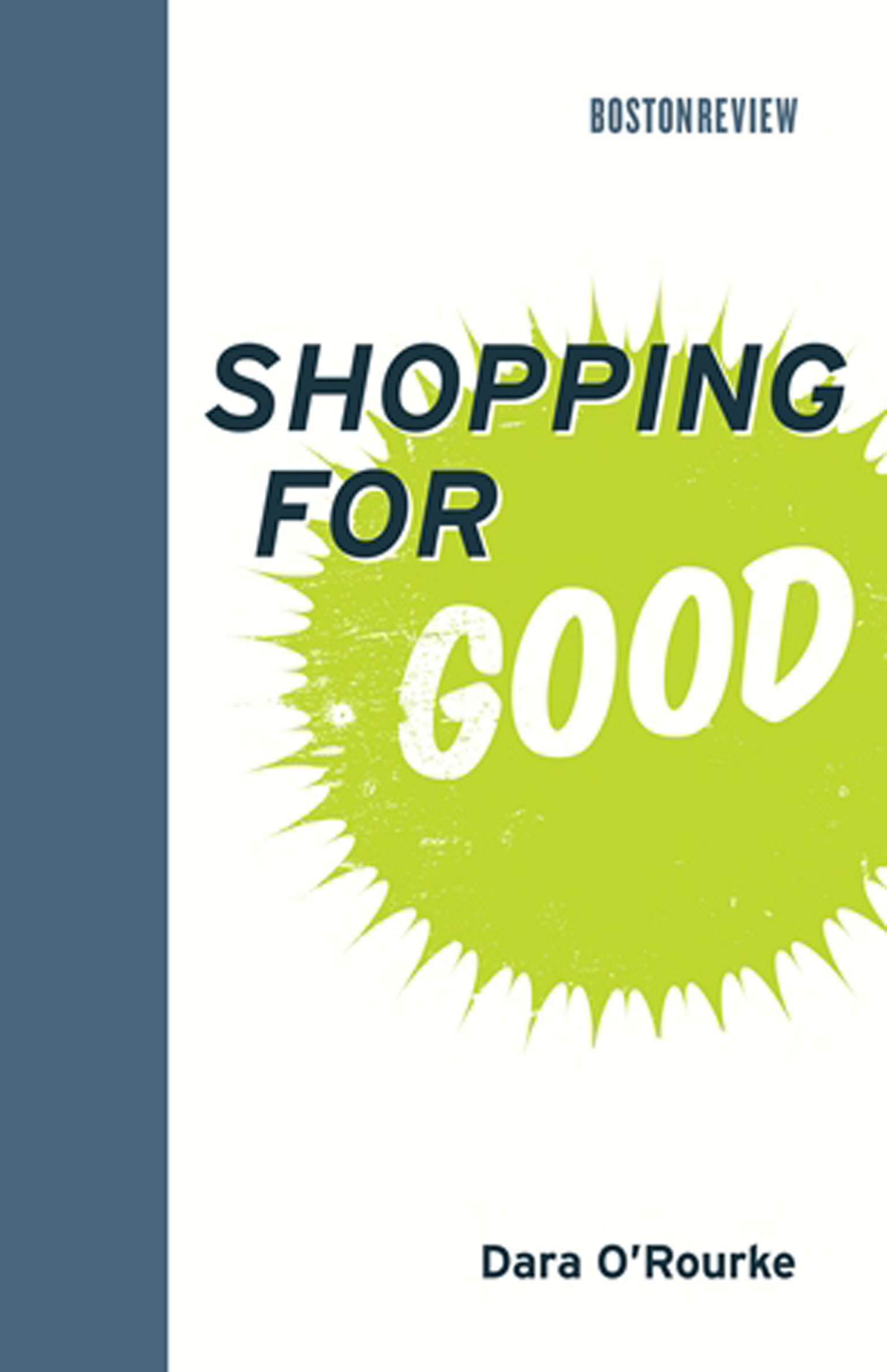
Shopping for Good Where public policy fails, can consumer choices lead the way to more ethical and sustainable production practices? “Buy local,” “buy green,” “buy organic,” “fair trade”—how effective has the ethical consumption movement been in changing market behavior? Can consumers create fair and sustainable supply chains by shopping selectively? Dara O'Rourke, the activist-scholar who first broke the news about Nike's sweatshops in the 1990s, considers the promise of ethical consumption—the idea that individuals, voting with their wallets, can promote better labor conditions and environmental outcomes globally. Governments have proven unable to hold companies responsible for labor and environmental practices. Consumers who say they want to support ethical companies often lack the knowledge and resources to do so consistently. But with the right tools, they may be able to succeed where governments have failed. Responding to O'Rourke's argument, eight experts—Juliet Schor, Richard Locke, Scott Nova, Lisa Ann Richey, Margaret Levi, Andrew Szasz, Scott Hartley, and Auret van Herdeen—consider the connections between personal concerns and consumer activism, challenge the value of entrusting regulation to consumer efforts, and draw attention to difficulties posed by global supply chains. POLITICAL SCIENCE,Public Policy,Environmental Policy
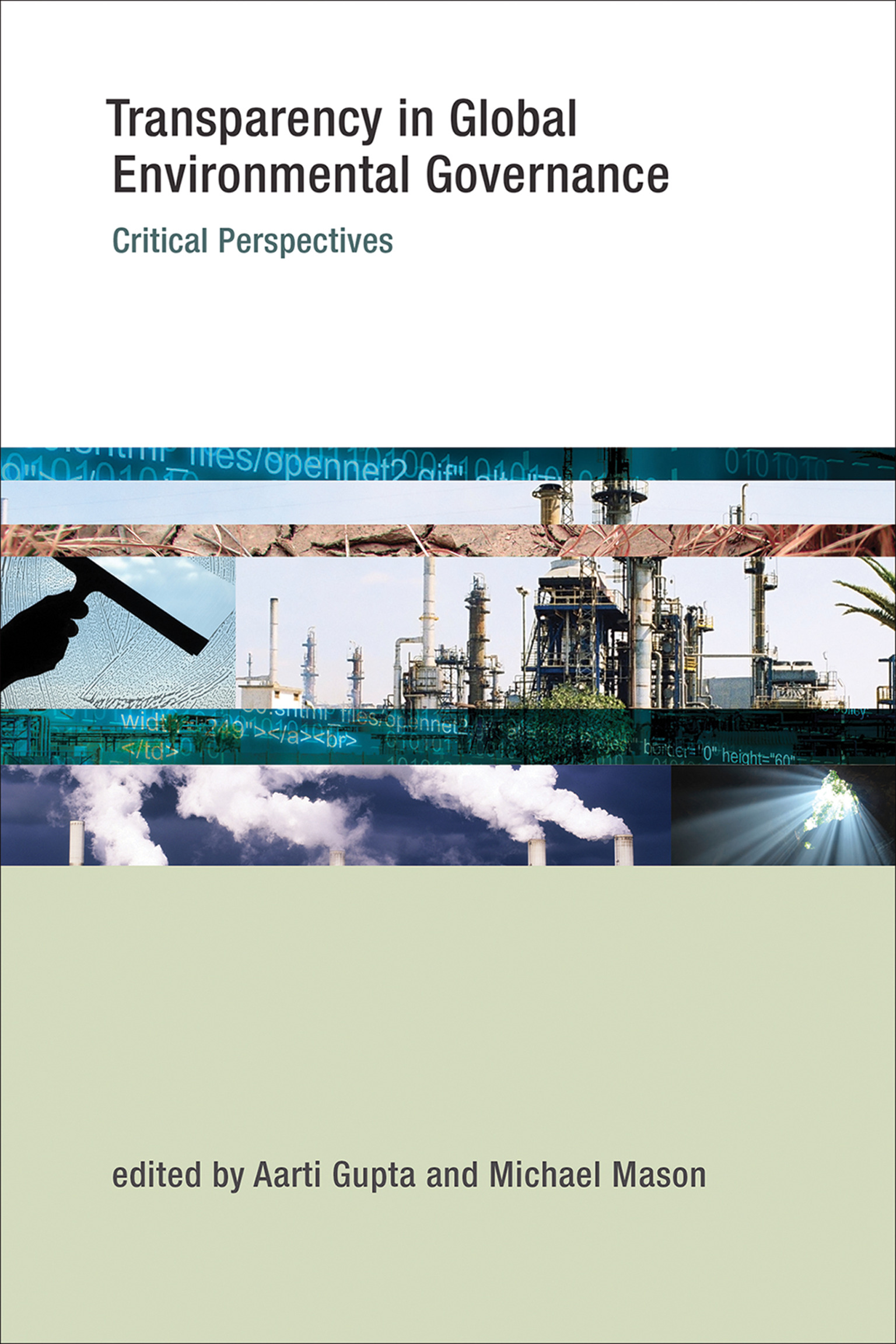
Transparency in Global Environmental Governance A critical assessment of whether transparency is a broadly transformative force in global environmental governance or plays a more limited role. Transparency—openness, secured through greater availability of information—is increasingly seen as part of the solution to a complex array of economic, political, and ethical problems in an interconnected world. The “transparency turn” in global environmental governance in particular is seen in a range of international agreements, voluntary disclosure initiatives, and public-private partnerships. This is the first book to investigate whether transparency in global environmental governance is in fact a broadly transformative force or plays a more limited, instrumental role. After three conceptual, context-setting chapters, the book examines ten specific and diverse instances of “governance by disclosure.” These include state-led mandatory disclosure initiatives that rely on such tools as prior informed consent and monitoring, measuring, reporting and verification; and private (or private-public), largely voluntary efforts that include such corporate transparency initiatives as the Carbon Disclosure Project and such certification schemes as the Forest Stewardship Council. The cases, which focus on issue areas including climate change, biodiversity, biotechnology, natural resource exploitation, and chemicals, demonstrate that although transparency is ubiquitous, its effects are limited and often specific to particular contexts. The book explores in what circumstances transparency can offer the possibility of a new emancipatory politics in global environmental governance. POLITICAL SCIENCE,Public Policy,Environmental Policy

Chemicals without Harm A proposal for a new chemicals strategy: that we work to develop safer alternatives to hazardous chemicals rather than focusing exclusively on controlling them. Today, there are thousands of synthetic chemicals used to make our clothing, cosmetics, household products, electronic devices, even our children's toys. Many of these chemicals help us live longer and more comfortable lives, but some of these highly useful chemicals are also persistent, toxic, and dangerous to our health and the environment. For fifty years, the conventional approach to hazardous chemicals has focused on regulation, barriers, and protection. In Chemicals without Harm, Ken Geiser proposes a different strategy, based on developing and adopting safer alternatives to hazardous chemicals rather than focusing exclusively on controlling them. Geiser reviews past government policies focused on controlling chemicals, describes government initiatives outside the United States that have begun to implement a more sustainable chemical policy, and offers an overview of the chemicals industry and market. He develops a safer chemicals policy framework that includes processes for characterizing, classifying, and prioritizing chemicals; generating and using new chemical information; and promoting transitions to safer chemicals. The shift in strategy described by Geiser will require broad changes in science, the chemicals economy, and government policy. Geiser shows that it is already beginning, identifying an emerging movement of scientists, corporate managers, environmental activists, and government leaders who are fashioning a new, twenty-first-century approach to chemicals. POLITICAL SCIENCE,Public Policy,Environmental Policy
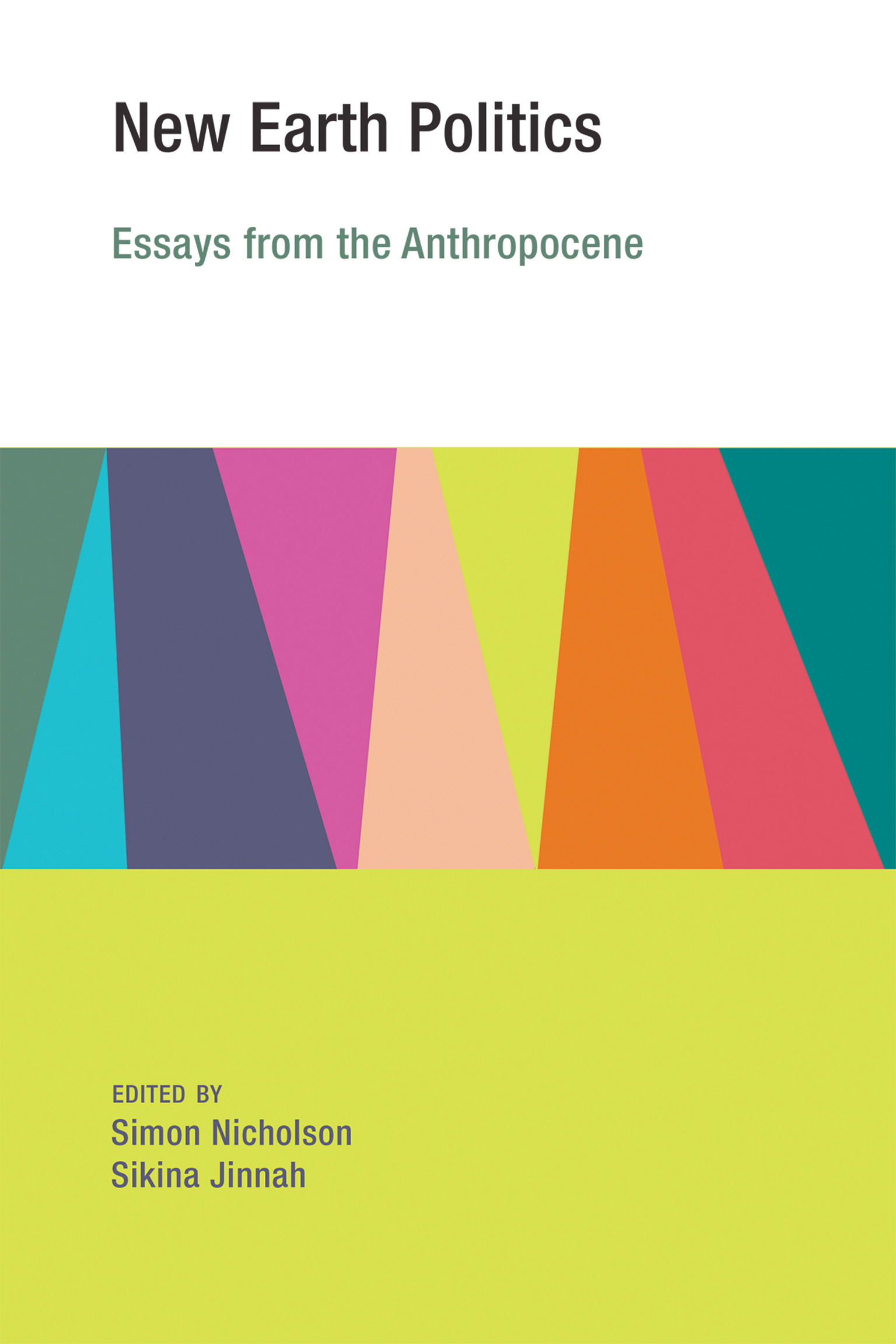
New Earth Politics Prominent scholars and practitioners consider the role of global environmental politics in the face of increasing environmental stress. Humanity's collective impact on the Earth is vast. The rate and scale of human-driven environmental destruction is quickly outstripping our political and social capacities for managing it. We are in effect creating an Earth 2.0 on which the human signature is everywhere, a “new earth” in desperate need of humane and insightful guidance. In this volume, prominent scholars and practitioners in the field of global environmental politics consider the ecological and political realities of life on the new earth, and probe the field's deepest and most enduring questions at a time of increasing environmental stress. Arranged in complementary pairs, the essays in this volume include reflections on environmental pedagogy, analysis of new geopolitical realities, reflections on the power of social movements and international institutions, and calls for more compelling narratives to promote environmental action. At the heart of the volume is sustained attention to the role of traditional scholarly activities in a world confronting environmental disaster. Some contributors make the case that it is the scholar's role to provide activists with the necessary knowledge and tools; others argue for more direct engagement and political action. All the contributors confront the overriding question: What is the best use of their individual and combined energies, given the dire environmental reality? Contributors Erik Assadourian, Frank Biermann, Wil Burns, Ken Conca, Peter Dauvergne, Daniel Deudney, Navroz Dubash, Richard Falk, Joyeeta Gupta, Maria Ivanova, Peter Jacques, Sikina Jinnah, Karen T. Litfin, Michael F. Maniates, Elizabeth Mendenhall, Simon Nicholson, Kate O'Neill, Judith Shapiro, Paul Wapner, Oran R. Young POLITICAL SCIENCE,Public Policy,Environmental Policy
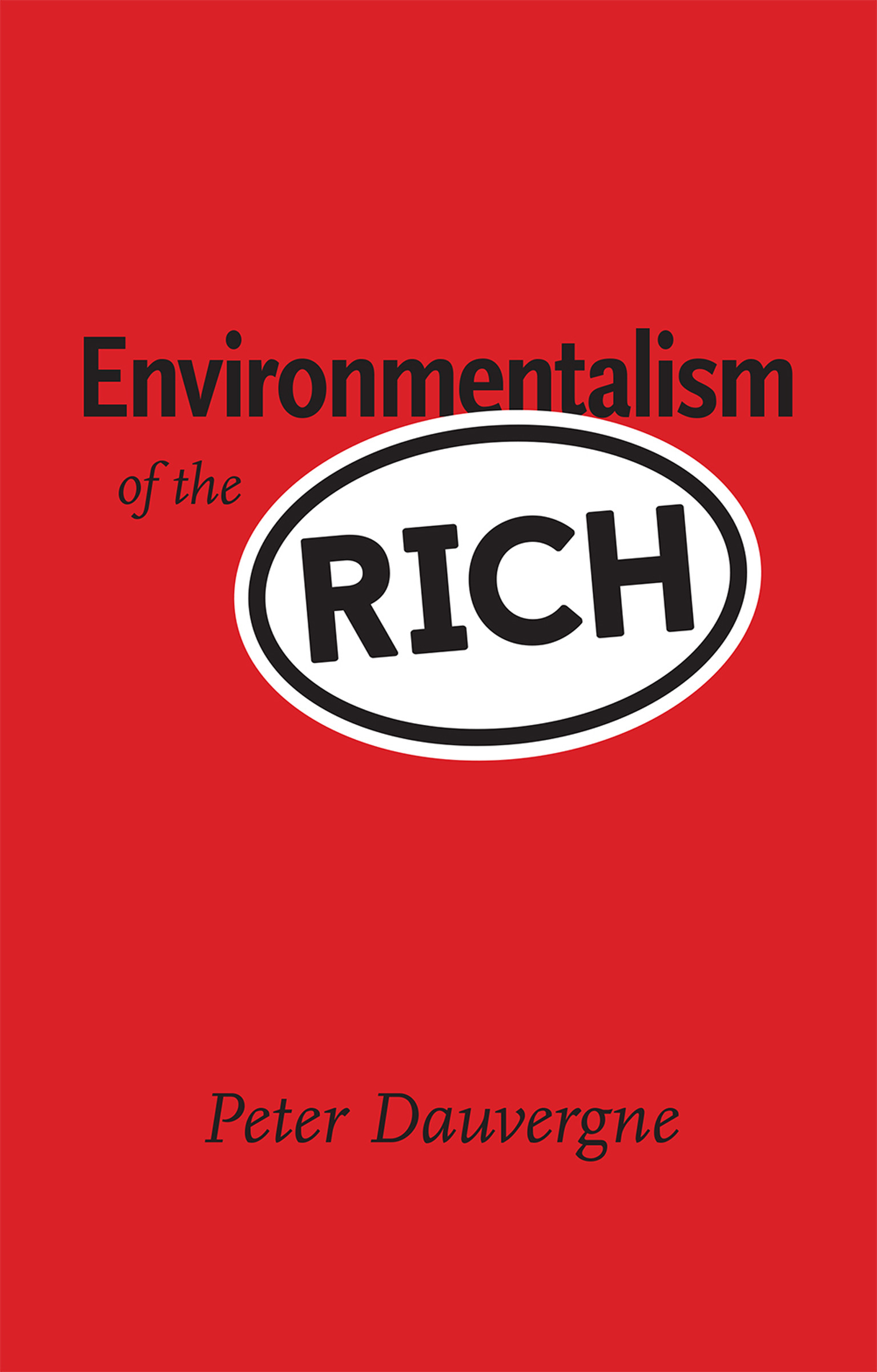
Environmentalism of the Rich What it means for global sustainability when environmentalism is dominated by the concerns of the affluent—eco-business, eco-consumption, wilderness preservation. Over the last fifty years, environmentalism has emerged as a clear counterforce to the environmental destruction caused by industrialization, colonialism, and globalization. Activists and policymakers have fought hard to make the earth a better place to live. But has the environmental movement actually brought about meaningful progress toward global sustainability? Signs of global “unsustainability” are everywhere, from decreasing biodiversity to scarcity of fresh water to steadily rising greenhouse gas emissions. Meanwhile, as Peter Dauvergne points out in this provocative book, the environmental movement is increasingly dominated by the environmentalism of the rich—diverted into eco-business, eco-consumption, wilderness preservation, energy efficiency, and recycling. While it's good that, for example, Barbie dolls' packaging no longer depletes Indonesian rainforest, and that Toyota Highlanders are available as hybrids, none of this gets at the source of the current sustainability crisis. More eco-products can just mean more corporate profits, consumption, and waste. Dauvergne examines extraction booms that leave developing countries poor and environmentally devastated—with the ruination of the South Pacific island of Nauru a case in point; the struggles against consumption inequities of courageous activists like Bruno Manser, who worked with indigenous people to try to save the rainforests of Borneo; and the manufacturing of vast markets for nondurable goods—for example, convincing parents in China that disposable diapers made for healthier and smarter babies. Dauvergne reveals why a global political economy of ever more—more growth, more sales, more consumption—is swamping environmental gains. Environmentalism of the rich does little to bring about the sweeping institutional change necessary to make progress toward global sustainability. POLITICAL SCIENCE,Public Policy,Environmental Policy

Reassembling Rubbish An examination of the global trade and traffic in discarded electronics that reframes the question of the “right” thing to do with e-waste. The prevailing storyline about the problem of electronic waste frames e-waste as generated by consumers in developed countries and dumped on people and places in developing countries. In Reassembling Rubbish, Josh Lepawsky offers a different view. In an innovative analysis of the global trade and traffic in discarded electronics, Lepawsky reframes the question of the “right” thing to do with e-waste, mapping the complex flows of electronic materials. He counters the assumption that e-waste is a post-consumer problem, pointing out that waste occurs at all stages of electronic materials' existence, and calls attention to the under-researched world of reuse and repair. Lepawsky explains that there are conflicting legal distinctions between electronic waste and non-waste, and examines a legal case that illustrates the consequences. He shows that patterns of trade do not support the dominant narrative of e-waste dumping but rather represent the dynamic ecologies of repair, refurbishment, and materials recovery. He asks how we know waste, how we measure it, and how we construe it, and how this affects our efforts to mitigate it. We might not put so much faith in household recycling if we counted the more massive amounts of pre-consumer electronic waste as official e-waste. Lepawsky charts the “minescapes,” “productionscapes,” and “clickscapes” of electronics, and the uneven “discardscapes” they produce. Finally, he considers both conventional and unconventional e-waste solutions, including decriminalizing export for reuse, repair, and upgrade; enabling ethical trade in electronics reuse, repair, refurbishment, and recycling; implementing extended producer responsibility; and instituting robust forms of public oversight. POLITICAL SCIENCE,Public Policy,Environmental Policy
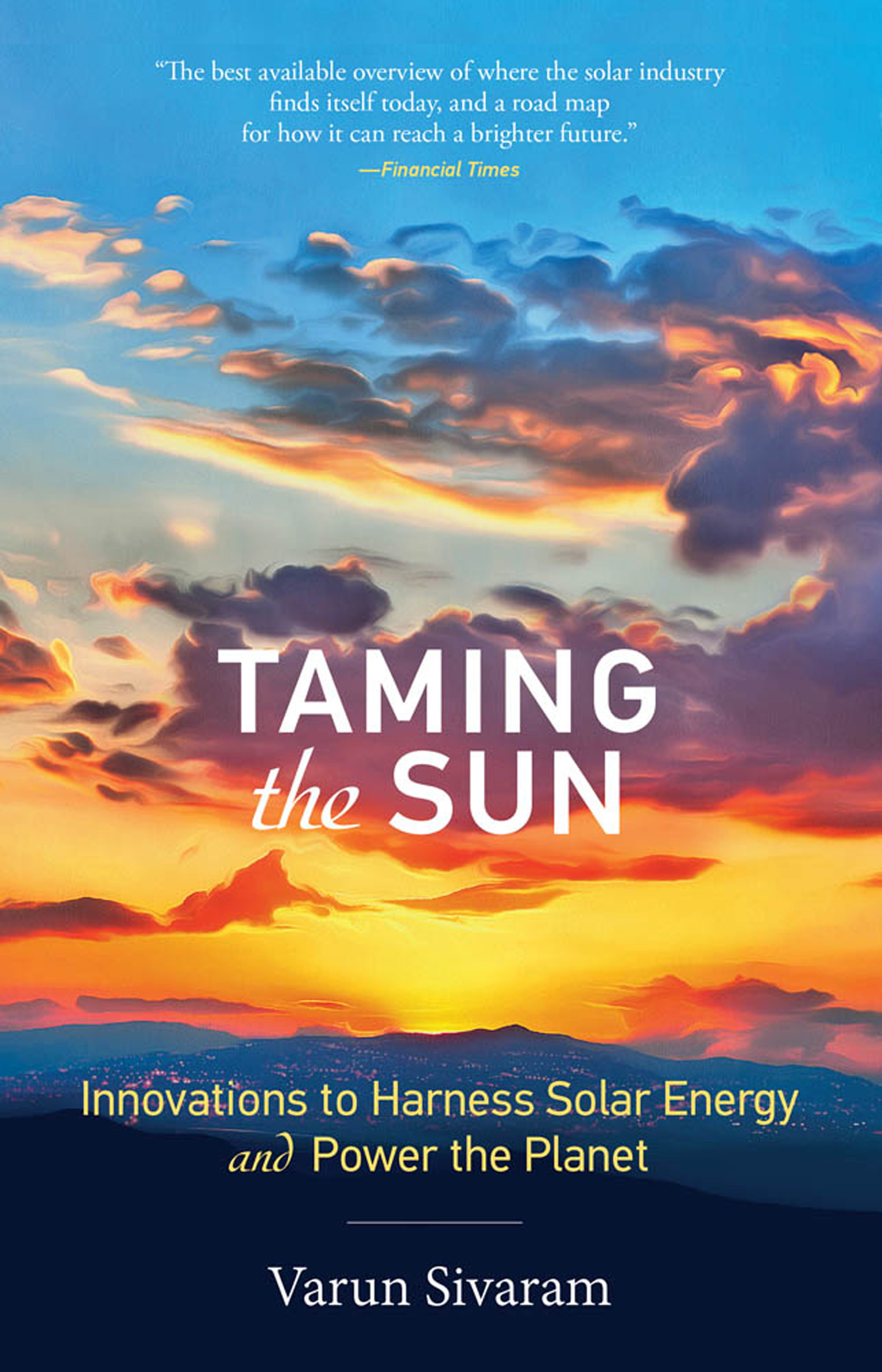
Taming the Sun How solar could spark a clean-energy transition through transformative innovation—creative financing, revolutionary technologies, and flexible energy systems. Solar energy, once a niche application for a limited market, has become the cheapest and fastest-growing power source on earth. What's more, its potential is nearly limitless—every hour the sun beams down more energy than the world uses in a year. But in Taming the Sun, energy expert Varun Sivaram warns that the world is not yet equipped to harness erratic sunshine to meet most of its energy needs. And if solar's current surge peters out, prospects for replacing fossil fuels and averting catastrophic climate change will dim. Innovation can brighten those prospects, Sivaram explains, drawing on firsthand experience and original research spanning science, business, and government. Financial innovation is already enticing deep-pocketed investors to fund solar projects around the world, from the sunniest deserts to the poorest villages. Technological innovation could replace today's solar panels with coatings as cheap as paint and employ artificial photosynthesis to store intermittent sunshine as convenient fuels. And systemic innovation could add flexibility to the world's power grids and other energy systems so they can dependably channel the sun's unreliable energy. Unleashing all this innovation will require visionary public policy: funding researchers developing next-generation solar technologies, refashioning energy systems and economic markets, and putting together a diverse clean energy portfolio. Although solar can't power the planet by itself, it can be the centerpiece of a global clean energy revolution. A Council on Foreign Relations Book POLITICAL SCIENCE,Public Policy,Environmental Policy

Global Environmental Governance and the Accountability Trap An examination of whether accountability mechanisms in global environmental governance that focus on monitoring and enforcement necessarily lead to better governance and better environmental outcomes. The rapid development of global environmental governance has been accompanied by questions of accountability. Efforts to address what has been called “a culture of unaccountability” include greater transparency, public justification for governance decisions, and the establishment of monitoring and enforcement procedures. And yet, as this volume shows, these can lead to an “accountability trap”—a focus on accountability measures rather than improved environmental outcomes. Through analyses and case studies, the contributors consider how accountability is being used within global environmental governance and if the proliferation of accountability tools enables governance to better address global environmental deterioration. Examining public, private, voluntary, and hybrid types of global environmental governance, the volume shows that the different governance goals of the various actors shape the accompanying accountability processes. These goals—from serving constituents to reaping economic benefits—determine to whom and for what the actors must account. After laying out a theoretical framework for its analyses, the book addresses governance in the key areas of climate change, biodiversity, fisheries, and trade and global value chains. The contributors find that normative biases shape accountability processes, and they explore the potential of feedback mechanisms between institutions and accountability rules for enabling better governance and better environmental outcomes. Contributors Graeme Auld, Harro van Asselt, Cristina Balboa, Lieke Brouwer, Lorraine Elliott, Lars H. Gulbrandsen, Aarti Gupta, Teresa Kramarz, Susan Park, Philipp Pattberg, William H. Schaedla, Hamish van der Ven, Oscar Widerberg POLITICAL SCIENCE,Public Policy,Environmental Policy
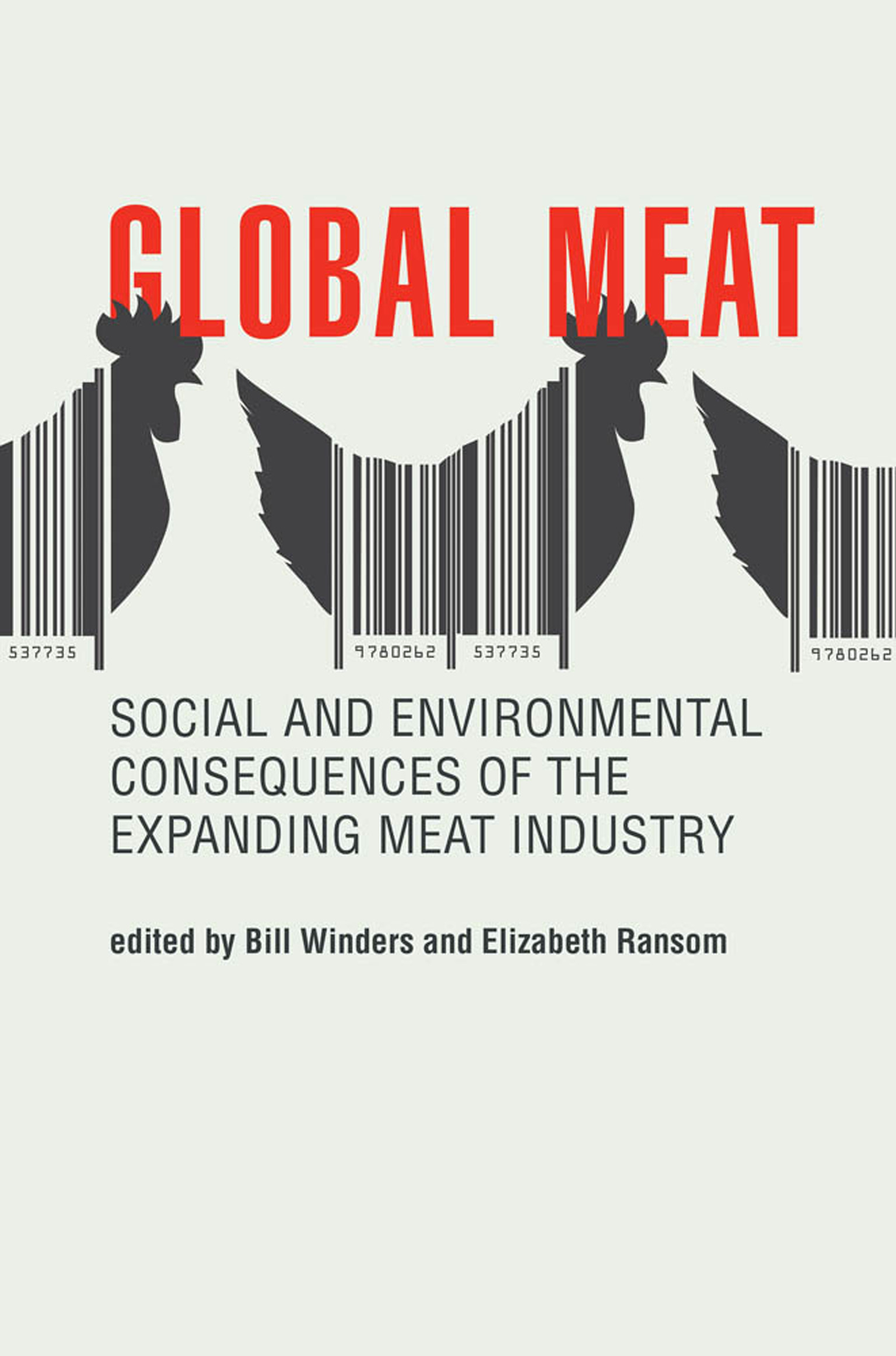
Global Meat The growth of the global meat industry and the implications for climate change, food insecurity, workers' rights, the treatment of animals, and other issues. Global meat production and consumption have risen sharply and steadily over the past five decades, with per capita meat consumption almost doubling since 1960. The expanding global meat industry, meanwhile, driven by new trade policies and fueled by government subsidies, is dominated by just a few corporate giants. Industrial farming—the intensive production of animals and fish—has spread across the globe. Millions of acres of land are now used for pastures, feed crops, and animal waste reservoirs. Drawing on concrete examples, the contributors to Global Meat explore the implications of the rise of a global meat industry for a range of social and environmental issues, including climate change, clean water supplies, hunger, workers' rights, and the treatment of animals. Three themes emerge from their discussions: the role of government and corporations in shaping the structure of the global meat industry; the paradox of simultaneous rising meat production and greater food insecurity; and the industry's contribution to social and environmental injustice. Contributors address such specific topics as the dramatic increase in pork production and consumption in China; land management by small-scale cattle farmers in the Amazon; the effect on the climate of rising greenhouse gas emissions from cattle raised for meat; and the tensions between economic development and animal welfare. Contributors Conner Bailey, Robert M. Chiles, Celize Christy, Riva C. H. Denny, Carrie Freshour, Philip H. Howard, Elizabeth Ransom, Tom Rudel, Mindi Schneider, Nhuong Tran, Bill Winders POLITICAL SCIENCE,Public Policy,Environmental Policy
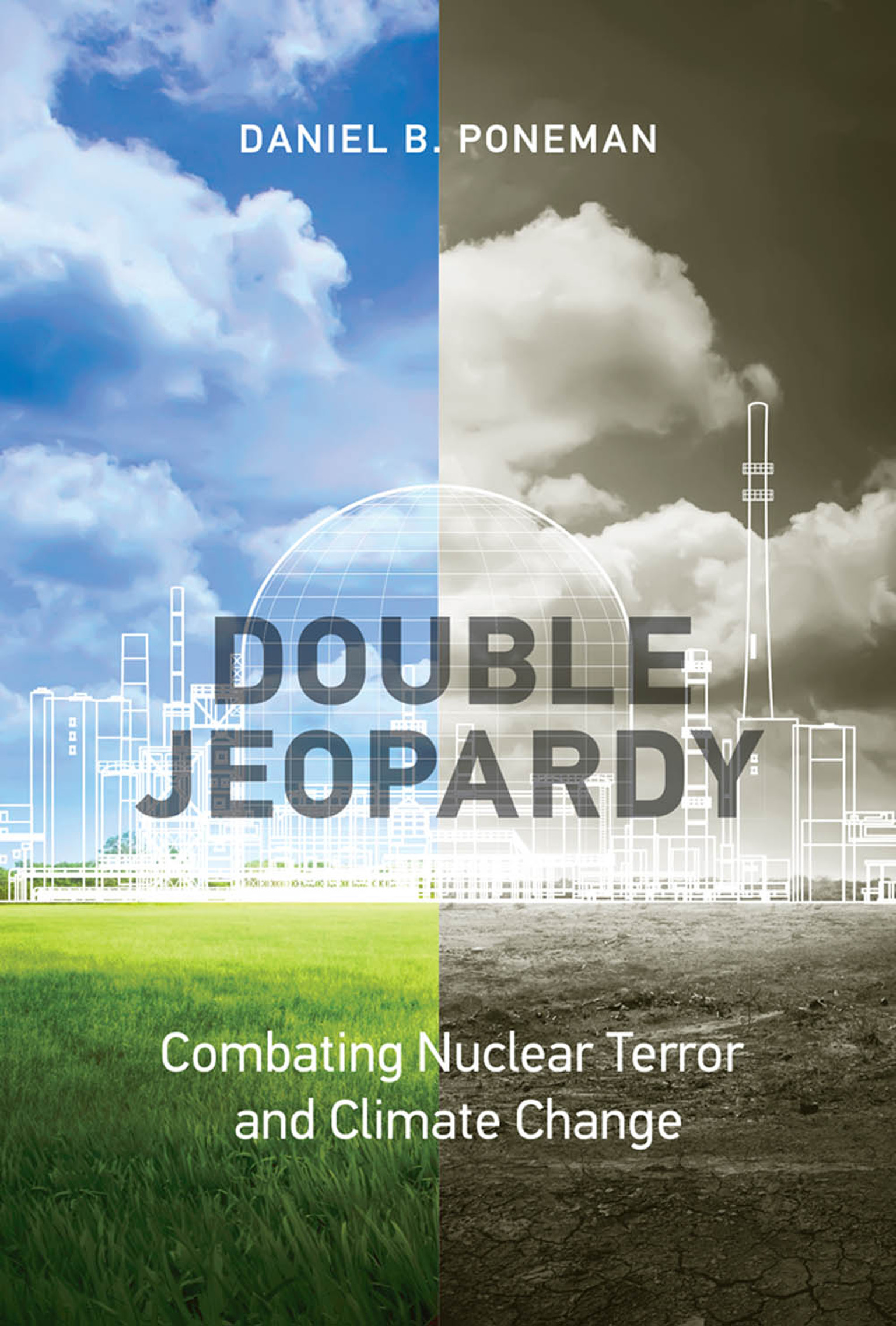
Double Jeopardy Making the case that we can use nuclear power to combat climate change even as we reduce the risks of nuclear terror. Humanity faces two existential threats: nuclear annihilation and catastrophic climate change. Both have human origins, and both are linked to the use of nuclear energy. Inherent in the use of atomic fission is the risk that the technology and materials can be diverted to terrorists or hostile nations and used to make nuclear weapons. The key question is whether we can use nuclear energy to reduce the threat of climate change without increasing the risk that nuclear weapons will be used. In Double Jeopardy, Daniel Poneman argues that the world needs an “all-of-the-above” energy policy, one that advances the goal of decarbonizing the environment through all available means—including nuclear power. Poneman makes a compelling case that we can enhance the ability of nuclear power to combat climate change even as we reduce the risks of nuclear terror. Doing so will require well-crafted laws and policies, implemented with an ethos of constant vigilance and embedded in a culture that weaves safety and security goals into the fabric of our nuclear programs. This will enable government and industry to work together to maximize energy and climate benefits while minimizing safety and security risks. POLITICAL SCIENCE,Public Policy,Environmental Policy

Structuring an Energy Technology Revolution An argument for a major federal program to stimulate innovation in energy technology and a proposal for a policy approach to implement it. America is addicted to fossil fuels, and the environmental and geopolitical costs are mounting. A public-private program—at an expanded scale—to stimulate innovation in energy policy seems essential. In Structuring an Energy Technology Revolution, Charles Weiss and William Bonvillian make the case for just such a program. Their proposal backs measures to stimulate private investment in new technology, within a revamped energy innovation system. It would encourage a broad range of innovations that would give policymakers a variety of technological options over the long implementation period and at the huge scale required, faster than could be accomplished by market forces alone. Even if the nation can't make progress at this time on pricing carbon, a technology strategy remains critical and can go ahead now. Strong leadership and public support will be needed to resist the pressure of entrenched interests against putting new technology pathways into practice in the complex and established energy sector. This book has helped start the process. POLITICAL SCIENCE,Public Policy,Environmental Policy
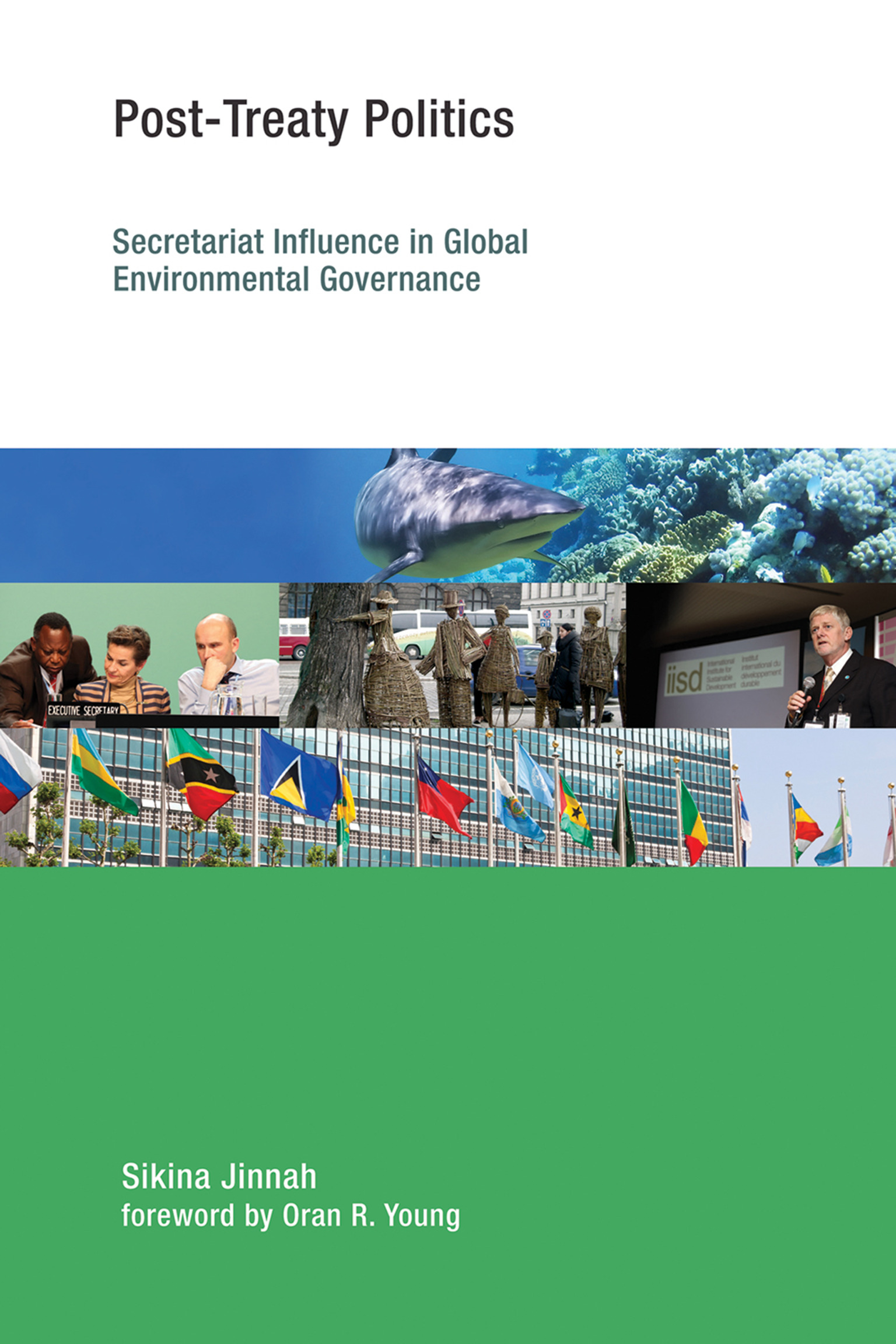
Post-Treaty Politics An argument that secretariats—the administrative arms of international treaties—are political actors in their own right. Secretariats—the administrative arms of international treaties—-would seem simply to do the bidding of member states. And yet, Sikina Jinnah argues in Post-Treaty Politics, secretariats can play an important role in world politics. On paper, secretariats collect information, communicate with state actors, and coordinate diplomatic activity. In practice, they do much more. As Jinnah shows, they can influence the allocation of resources, structures of interstate cooperation, and the power relationships between states. Jinnah examines secretariat influence through the lens of overlap management in environmental governance—how secretariats help to manage the dense interplay of issues, rules, and norms between international treaty regimes. Through four case studies, she shows that secretariats can draw on their unique networks and expertise to handle the challenges of overlap management, emerging as political actors in their own right. After presenting a theory and analytical framework for analyzing secretariat influence, Jinnah examines secretariat influence on overlap management within the Convention on Biological Diversity (CBD), two cases of overlap management in the World Trade Organization, as well as a case in which the Convention on International Trade in Endangered Species (CITES) secretariat failed to influence political outcomes despite its efforts to manage overlap. Jinnah argues that, even when modest, secretariat influence matters because it can establish a path-dependent dynamic that continues to guide state behavior even after secretariat influence has waned. POLITICAL SCIENCE,Public Policy,Environmental Policy
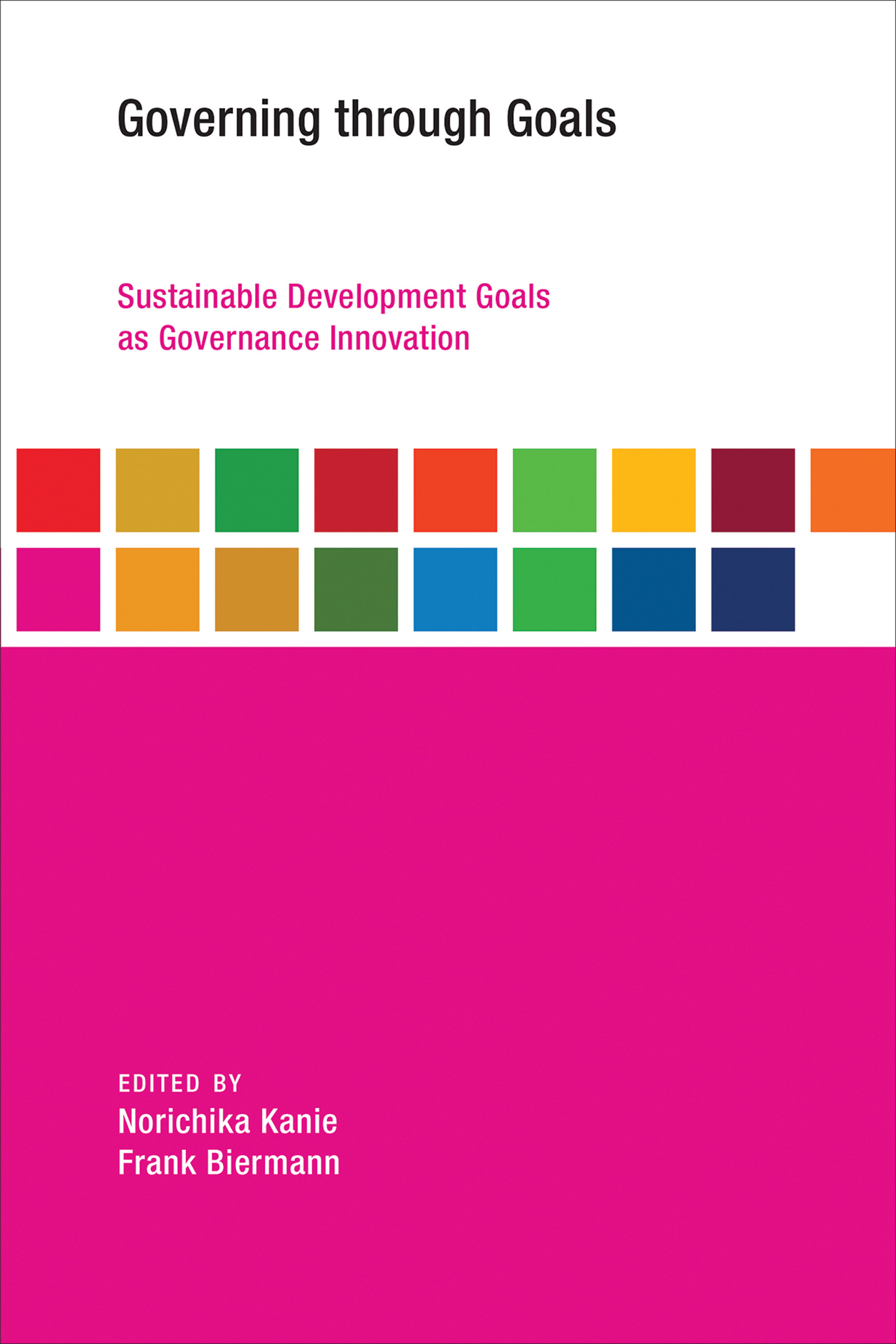
Governing through Goals A detailed examination of the UN's Sustainable Development Goals and the shift in governance strategy they represent. In September 2015, the United Nations General Assembly adopted the Sustainable Development Goals as part of the 2030 Agenda for Sustainable Development. The Sustainable Development Goals built on and broadened the earlier Millennium Development Goals, but they also signaled a larger shift in governance strategies. The seventeen goals add detailed content to the concept of sustainable development, identify specific targets for each goal, and help frame a broader, more coherent, and transformative 2030 agenda. The Sustainable Development Goals aim to build a universal, integrated framework for action that reflects the economic, social, and planetary complexities of the twenty-first century. This book examines in detail the core characteristics of goal setting, asking when it is an appropriate governance strategy and how it differs from other approaches; analyzes the conditions under which a goal-oriented agenda can enable progress toward desired ends; and considers the practical challenges in implementation. Contributors Dora Almassy, Steinar Andresen, Noura Bakkour, Steven Bernstein, Frank Biermann, Thierry Giordano, Aarti Gupta, Joyeeta Gupta, Peter M. Haas, Masahiko Iguchi, Norichika Kanie, Rakhyun E. Kim Marcel Kok, Kanako Morita, Måns Nilsson, László Pintér, Michelle Scobie, Noriko Shimizu, Casey Stevens, Arild Underdal, Tancrède Voituriez, Takahiro Yamada, Oran R. Young POLITICAL SCIENCE,Public Policy,Environmental Policy

Climate of Capitulation How power is wielded in environmental policy making at the state level, and how to redress the ingrained favoritism toward coal and electric utilities. The United States has pledged to the world community a reduction in greenhouse gas emissions by 26–28 percent below 2005 levels in 2025. Because much of this reduction must come from electric utilities, especially coal-fired power plants, coal states will make or break the U.S. commitment to emissions reduction. In Climate of Capitulation, Vivian Thomson offers an insider's account of how power is wielded in environmental policy making at the state level. Thomson, a former member of Virginia's State Air Pollution Control Board, identifies a “climate of capitulation” in state government—a deeply rooted favoritism toward coal and electric utilities in states' air pollution policies. Thomson narrates three cases involving coal and air pollution from her time on the Air Board. She illuminates the overt and covert power struggles surrounding air pollution limits for a coal-fired power plant just across the Potomac from Washington, for a controversial new coal-fired electrical generation plant in coal country, and for coal dust pollution from truck traffic in a country hollow. Thomson links Virginia's climate of capitulation with campaign donations that make legislators politically indebted to coal and electric utility interests, a traditionalistic political culture tending to inertia, and a part-time legislature that depended on outside groups for information and bill drafting. Extending her analysis to fifteen other coal-dependent states, Thomson offers policy reforms aimed at mitigating the ingrained biases toward coal and electric utilities in states' air pollution policy making. POLITICAL SCIENCE,Public Policy,Environmental Policy

Can We Price Carbon? A political science analysis of the feasibility and sustainability of carbon pricing, drawing from North American, European, and Asian case studies. Climate change, economists generally agree, is best addressed by putting a price on the carbon content of fossil fuels—by taxing carbon, by cap-and-trade systems, or other methods. But what about the politics of carbon pricing? Do political realities render carbon pricing impracticable? In this book, Barry Rabe offers the first major political science analysis of the feasibility and sustainability of carbon pricing, drawing upon a series of real-world attempts to price carbon over the last two decades in North America, Europe, and Asia. Rabe asks whether these policies have proven politically viable and, if adopted, whether they survive political shifts and managerial challenges over time. The entire policy life cycle is examined, from adoption through advanced implementation, on a range of pricing policies including not only carbon taxes and cap-and-trade but also such alternative methods as taxing fossil fuel extraction. These case studies, Rabe argues, show that despite the considerable political difficulties, carbon pricing can be both feasible and durable. POLITICAL SCIENCE,Public Policy,Environmental Policy
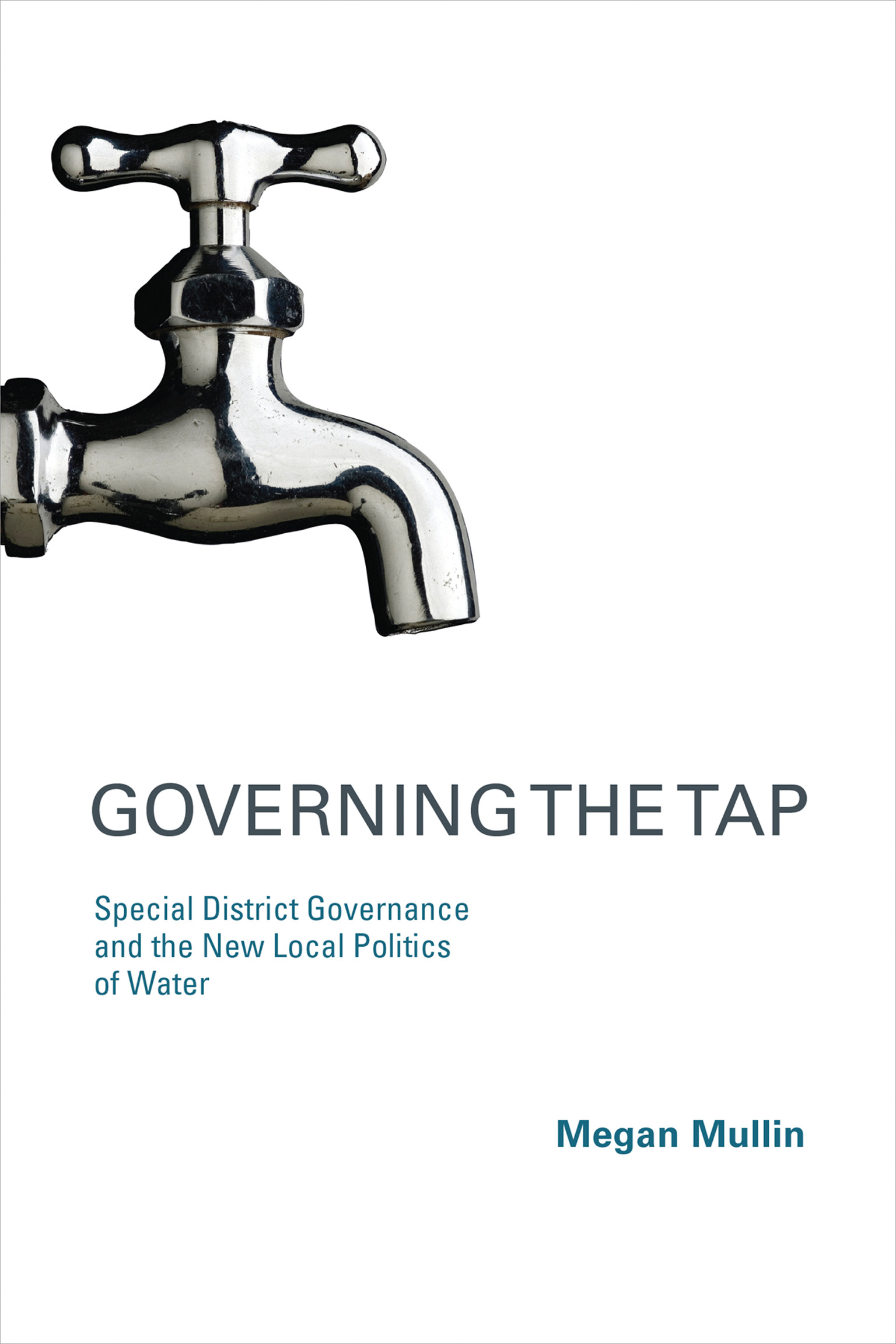
Governing the Tap An analysis of the political consequences of special district governance in drinking water management that offers new insights into the influence of political structures on local policymaking. More than ever, Americans rely on independent special districts to provide public services. The special district—which can be as small as a low-budget mosquito abatement district or as vast as the Port Authority of New York and New Jersey—has become the most common form of local governance in the United States. In Governing the Tap, Megan Mullin examines the consequences of specialization and the fragmentation of policymaking authority through the lens of local drinking-water policy. Directly comparing specific conservation, land use, and contracting policies enacted by different forms of local government, Mullin investigates the capacity of special districts to engage in responsive and collaborative decision making that promotes sustainable use of water resources. She concludes that the effect of specialization is conditional on the structure of institutions and the severity of the policy problem, with specialization offering the most benefit on policy problems that are least severe. Mullin presents a political theory of specialized governance that is relevant to any of the variety of functions special districts perform. Governing the Tap offers not only the first study of how the new decentralized politics of water is taking shape in American communities, but also new and important findings about the influence of institutional structures on local policymaking. POLITICAL SCIENCE,Public Policy,Environmental Policy
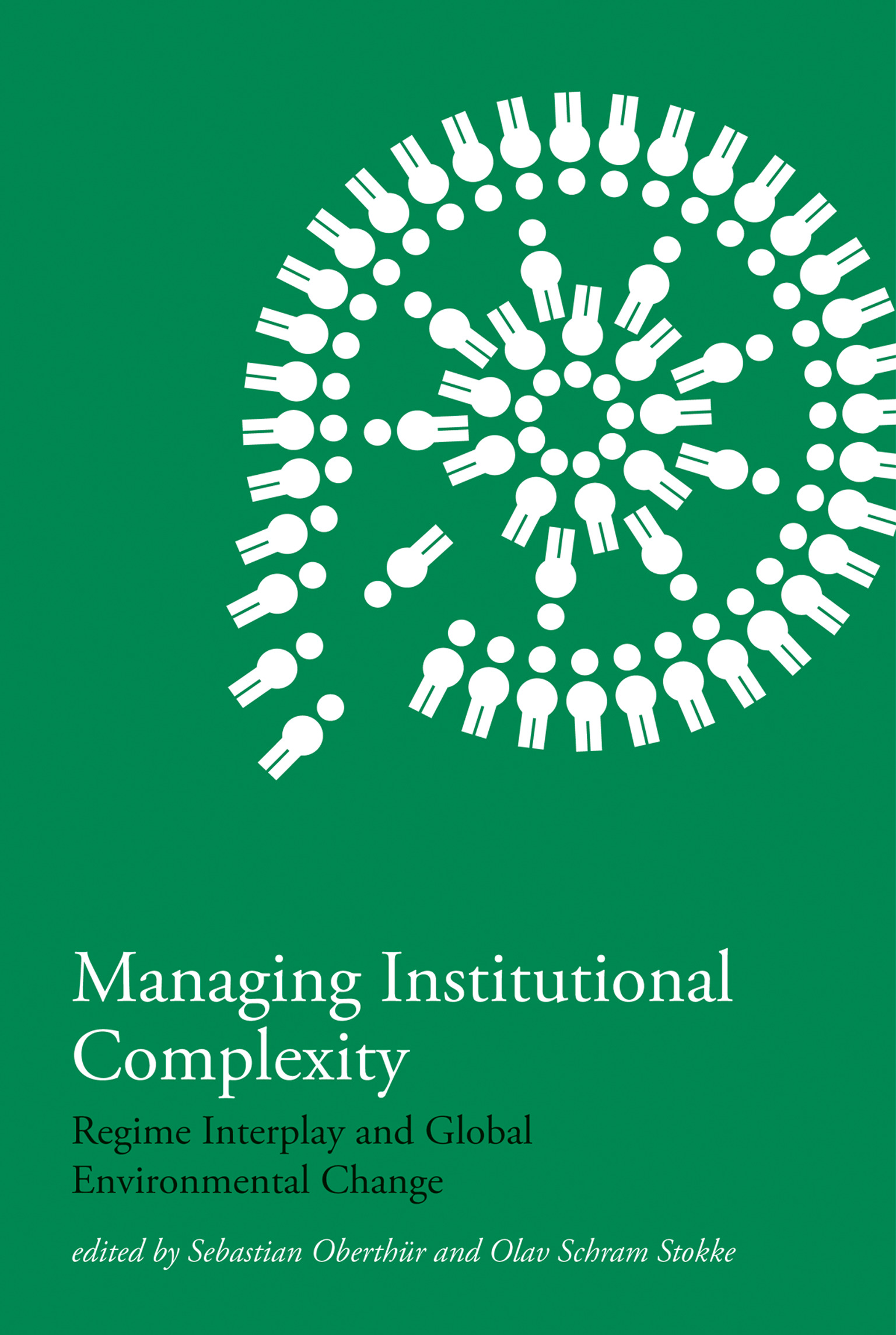
Managing Institutional Complexity Experts investigate how states and other actors can improve inter-institutional synergy and examine the complexity of overlapping environmental governance structures. Institutional interaction and complexity are crucial to environmental governance and are quickly becoming dominant themes in the international relations and environmental politics literatures. This book examines international institutional interplay and its consequences, focusing on two important issues: how states and other actors can manage institutional interaction to improve synergy and avoid disruption; and what forces drive the emergence and evolution of institutional complexes, sets of institutions that cogovern particular issue areas. The book, a product of the Institutional Dimensions of Global Environmental Change research project (IDGEC), offers both theoretical and empirical perspectives. Chapters range from analytical overviews to case studies of institutional interaction, interplay management, and regime complexes in areas including climate change, fisheries management, and conservation of biodiversity. Contributors discuss such issues as the complicated management of fragmented multilateral institutions addressing climate change; the possible “chilling effect” on environmental standards from existing commitments; governance niches in Arctic resource protection; the relationships among treaties on conservation and use of plant genetic resources; causal factors in cross-case variation of regime prevalence; and the difficult relationship between the World Trade Organization and multilateral environmental agreements. The book offers a broad overview of research on interplay management and institutional complexes that provides important insights across the field of global environmental governance. POLITICAL SCIENCE,Public Policy,Environmental Policy
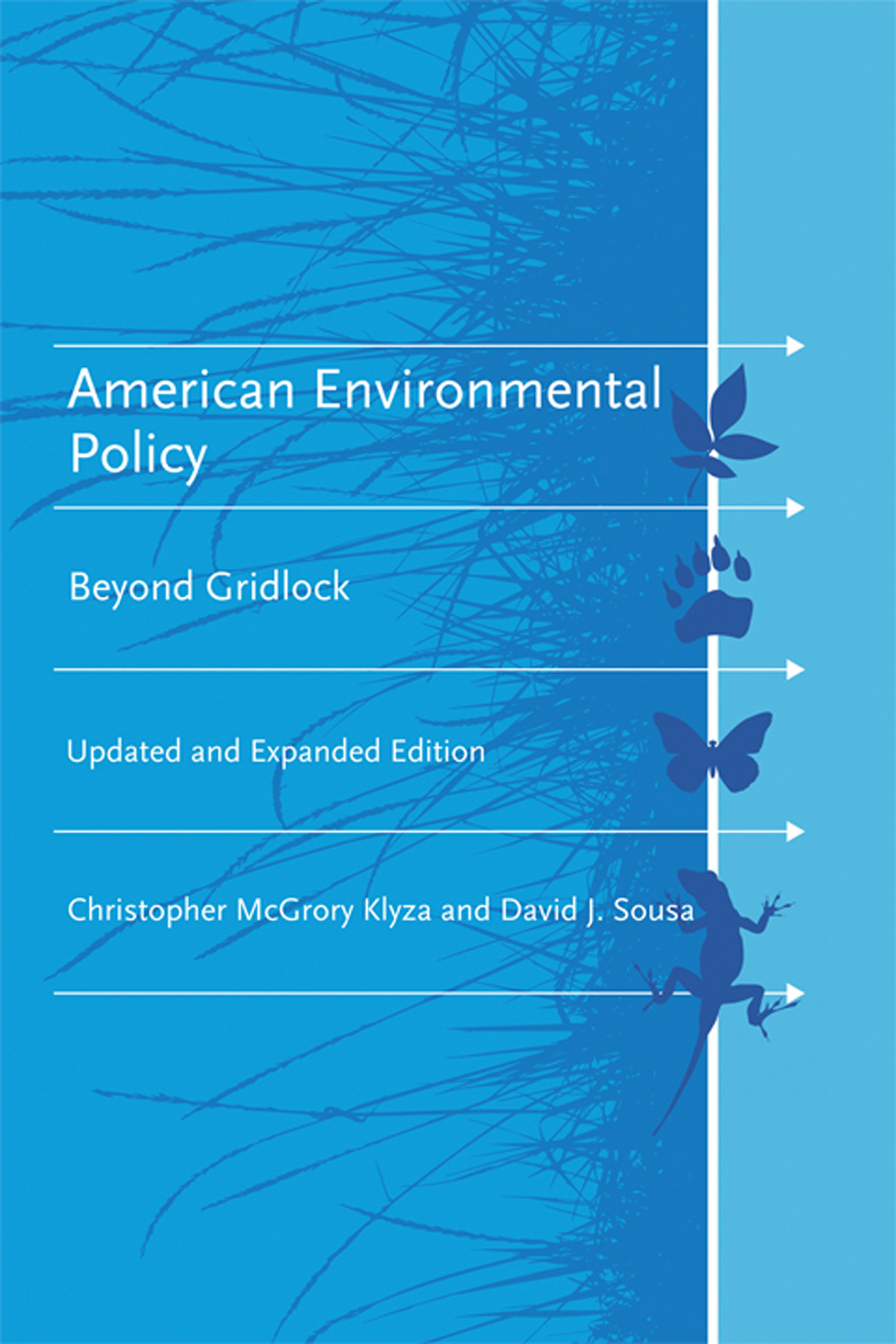
American Environmental Policy, updated and expanded edition An updated investigation of alternate pathways for American environmental policymaking made necessary by legislative gridlock. The “golden era” of American environmental lawmaking in the 1960s and 1970s saw twenty-two pieces of major environmental legislation (including the Clean Air Act, the Clean Water Act, and the Endangered Species Act) passed by bipartisan majorities in Congress and signed into law by presidents of both parties. But since then partisanship, the dramatic movement of Republicans to the right, and political brinksmanship have led to legislative gridlock on environmental issues. In this book, Christopher Klyza and David Sousa argue that the longstanding legislative stalemate at the national level has forced environmental policymaking onto other pathways. Klyza and Sousa identify and analyze five alternative policy paths, which they illustrate with case studies from 1990 to the present: “appropriations politics” in Congress; executive authority; the role of the courts; “next-generation” collaborative experiments; and policymaking at the state and local levels. This updated edition features a new chapter discussing environmental policy developments from 2006 to 2012, including intensifying partisanship on the environment, the failure of Congress to pass climate legislation, the ramifications of Massachusetts v. EPA, and other Obama administration executive actions (some of which have reversed Bush administration executive actions). Yet, they argue, despite legislative gridlock, the legacy of 1960s and 1970s policies has created an enduring “green state” rooted in statutes, bureaucratic routines, and public expectations. POLITICAL SCIENCE,Public Policy,Environmental Policy
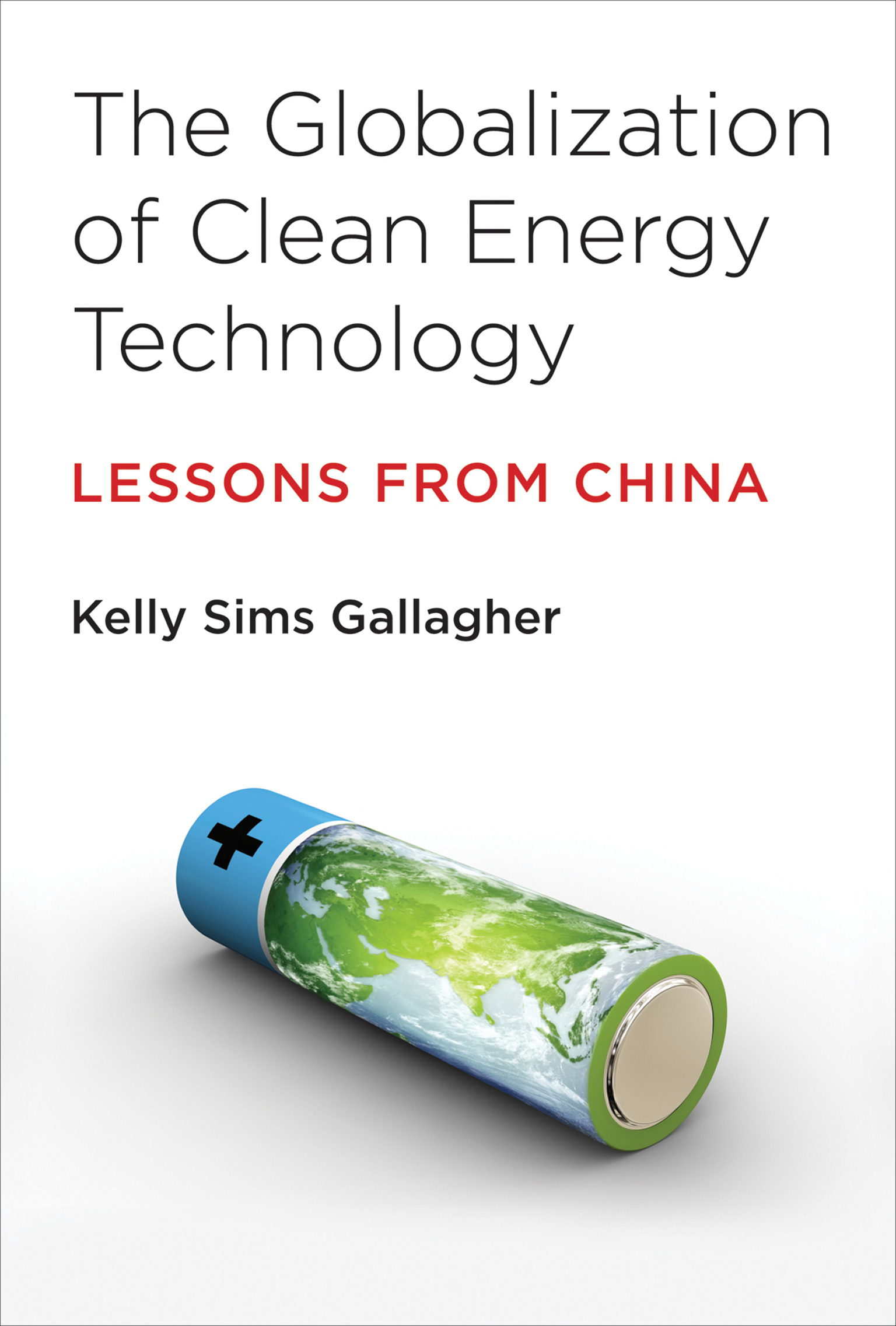
The Globalization of Clean Energy Technology An examination of barriers that impede and incentives that motivate the global development and deployment of cleaner energy technologies, with case studies from China. The development and deployment of cleaner energy technologies have become globalized phenomena. Yet despite the fact that energy-related goods account for more than ten percent of international trade, policy makers, academics, and the business community perceive barriers to the global diffusion of these emerging technologies. Experts point to problems including intellectual property concerns, trade barriers, and developing countries' limited access to technology and funding. In this book, Kelly Gallagher uses analysis and case studies from China's solar photovoltaic, gas turbine, advanced battery, and coal gasification industries to examine both barriers and incentives in clean energy technology transfer. Gallagher finds that the barriers are not as daunting as many assume; these technologies already cross borders through foreign direct investment, licensing, joint R&D, and other channels. She shows that intellectual property infringement is not as widespread as business leaders fear and can be managed, and that firms in developing countries show considerable resourcefulness in acquiring technology legally. She finds that financing does present an obstacle, especially when new cleaner technologies compete with entrenched, polluting, and often government-subsidized traditional technologies. But the biggest single barrier, she finds, is the failure of government to provide sensible policy incentives. The case studies show how government, through market-formation policy, can unleash global market forces. Gallagher's findings have theoretical significance as well; she proposes a new model of global technology diffusion that casts doubt on aspects of technology transfer theory. POLITICAL SCIENCE,Public Policy,Environmental Policy
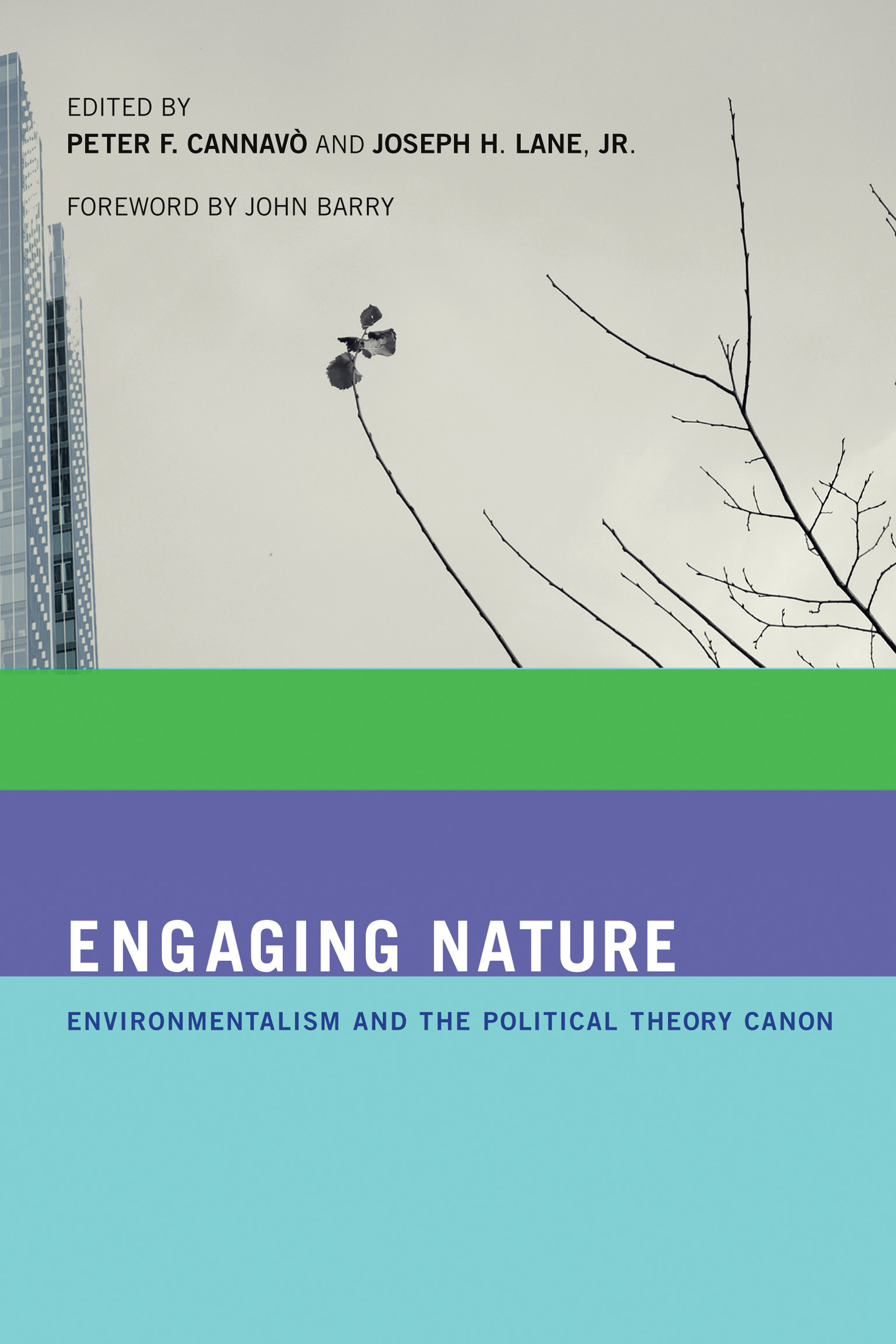
Engaging Nature Essays that put noted political thinkers of the past—including Plato, Machiavelli, Hobbes, Wollstonecraft, Marx, and Confucius—in dialogue with current environmental political theory. Contemporary environmental political theory considers the implications of the environmental crisis for such political concepts as rights, citizenship, justice, democracy, the state, race, class, and gender. As the field has matured, scholars have begun to explore connections between Green Theory and such canonical political thinkers as Plato, Machiavelli, Locke, and Marx. The essays in this volume put important figures from the political theory canon in dialogue with current environmental political theory. It is the first comprehensive volume to bring the insights of Green Theory to bear in reinterpreting these canonical theorists. Individual essays cover such classical figures in Western thought as Aristotle, Hume, Rousseau, Mill, and Burke, but they also depart from the traditional canon to consider Mary Wollstonecraft, W. E. B. Du Bois, Hannah Arendt, and Confucius. Engaging and accessible, the essays also offer original and innovative interpretations that often challenge standard readings of these thinkers. In examining and explicating how these great thinkers of the past viewed the natural world and our relationship with nature, the essays also illuminate our current environmental predicament. Essays on Plato • Aristotle • Niccolò Machiavelli • Thomas Hobbes • John Locke • David Hume • Jean-Jacques Rousseau • Edmund Burke • Mary Wollstonecraft • John Stuart Mill • Karl Marx • W. E. B. Du Bois • Martin Heidegger • Hannah Arendt • Confucius Contributors Sheryl D. Breen, W. Scott Cameron, Peter F. Cannavò, Joel Jay Kassiola, Joseph H. Lane Jr. Timothy W. Luke, John M. Meyer, Özgüç Orhan, Barbara K. Seeber, Francisco Seijo, Kimberly K. Smith, Piers H. G. Stephens, Zev Trachtenberg, Andrew Valls, Harlan Wilson POLITICAL SCIENCE,Public Policy,Environmental Policy
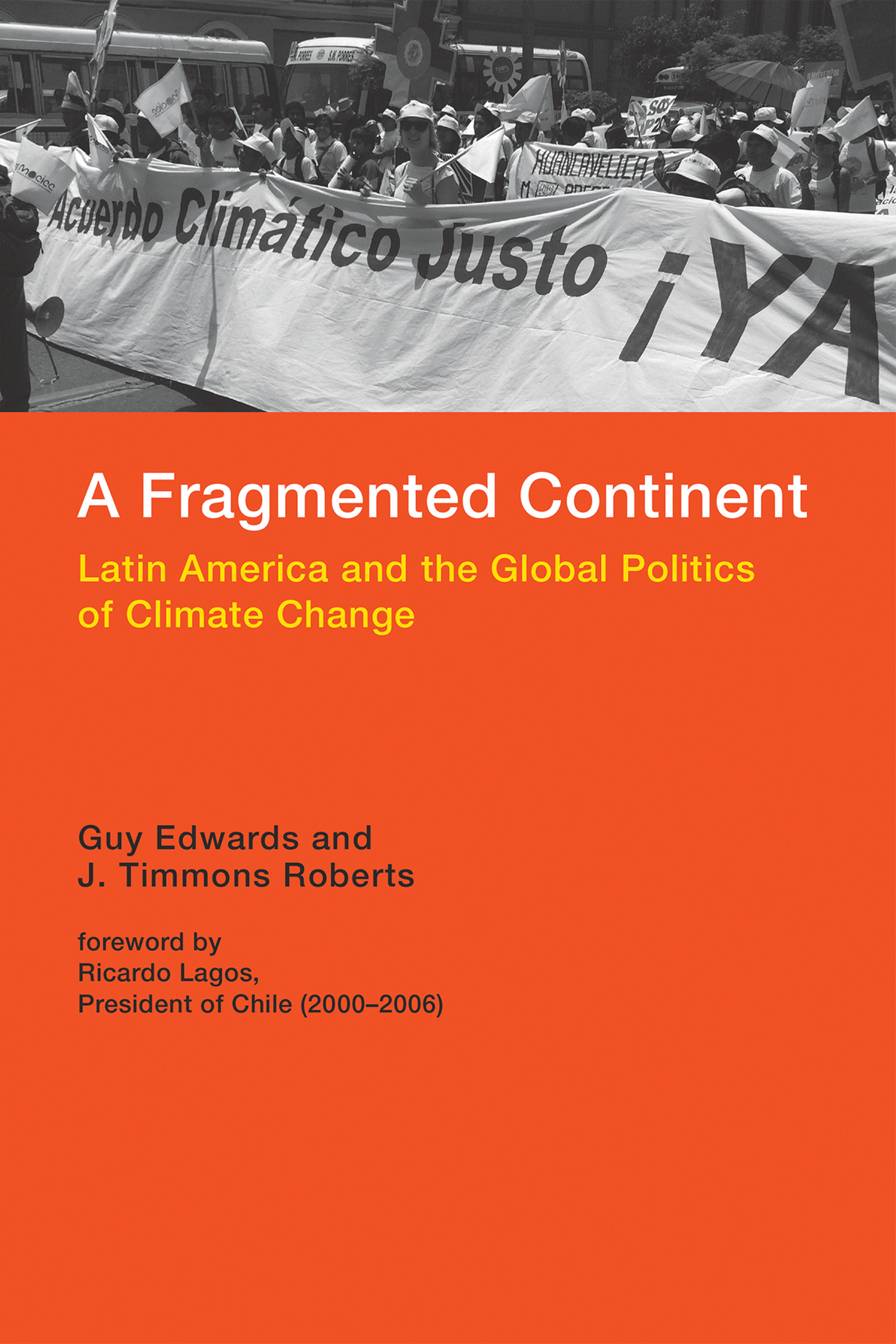
A Fragmented Continent How Latin American countries became leading voices and innovators on addressing climate change—and what threatens their leadership. Latin American countries have increased their influence at the United Nations climate change negotiations and offered potential solutions on coping with global warming. But in the face of competing priorities, sometimes these climate policies are jettisoned, undermined, or simply ignored. A Fragmented Continent focuses on Latin America's three major blocs at the U.N. climate negotiations and how they attempt to balance climate action with building prosperity. Brazil has reduced its deforestation but continues its drive for economic growth and global recognition. A leftist group led by Venezuela, Bolivia, and Ecuador decries the injustice of climate change but is highly dependent on the export of fossil fuels. A new group, including Chile, Costa Rica, and Peru and supported by Mexico, offers sharp reductions in their carbon emissions in return for greater action by others; these countries now have to deliver on their promises. Weaving together issues of politics and economy, trade, foreign policy, civil society, and environmental protection, A Fragmented Continent offers a long-missing perspective on one of this century's greatest challenges and neglected regions. POLITICAL SCIENCE,Public Policy,Environmental Policy

Conceptual Innovation in Environmental Policy Concepts and their role in the evolution of modern environmental policy, with case studies of eleven influential concepts ranging from “environment” to “sustainable consumption.” Concepts are thought categories through which we apprehend the world; they enable, but also constrain, reasoning and debate and serve as building blocks for more elaborate arguments. This book traces the links between conceptual innovation in the environmental sphere and the evolution of environmental policy and discourse. It offers both a broad framework for examining the emergence, evolution, and effects of policy concepts and a detailed analysis of eleven influential environmental concepts. In recent decades, conceptual evolution has been particularly notable in environmental governance, as new problems have emerged and as environmental issues have increasingly intersected with other areas. “Biodiversity,” for example, was unheard of until the late 1980s; “negative carbon emissions” only came into being over the last few years. After a review of concepts and their use in environmental argument, chapters chart the trajectories of a range of environmental concepts: environment, sustainable development, biodiversity, environmental assessment, critical loads, adaptive management, green economy, environmental risk, environmental security, environmental justice, and sustainable consumption. The book provides a valuable resource for scholars and policy makers and also offers a novel introduction to the environmental policy field through the evolution of its conceptual categories. Contributors Richard N. L. Andrews, Karin Bäckstrand, Karen Baehler, Daniel J. Fiorino, Yrjö Haila, Michael E. Kraft, Oluf Langhelle, Judith A. Layzer, James Meadowcroft, Alexis Schulman, Johannes Stripple, Philip J. Vergragt POLITICAL SCIENCE,Public Policy,Environmental Policy
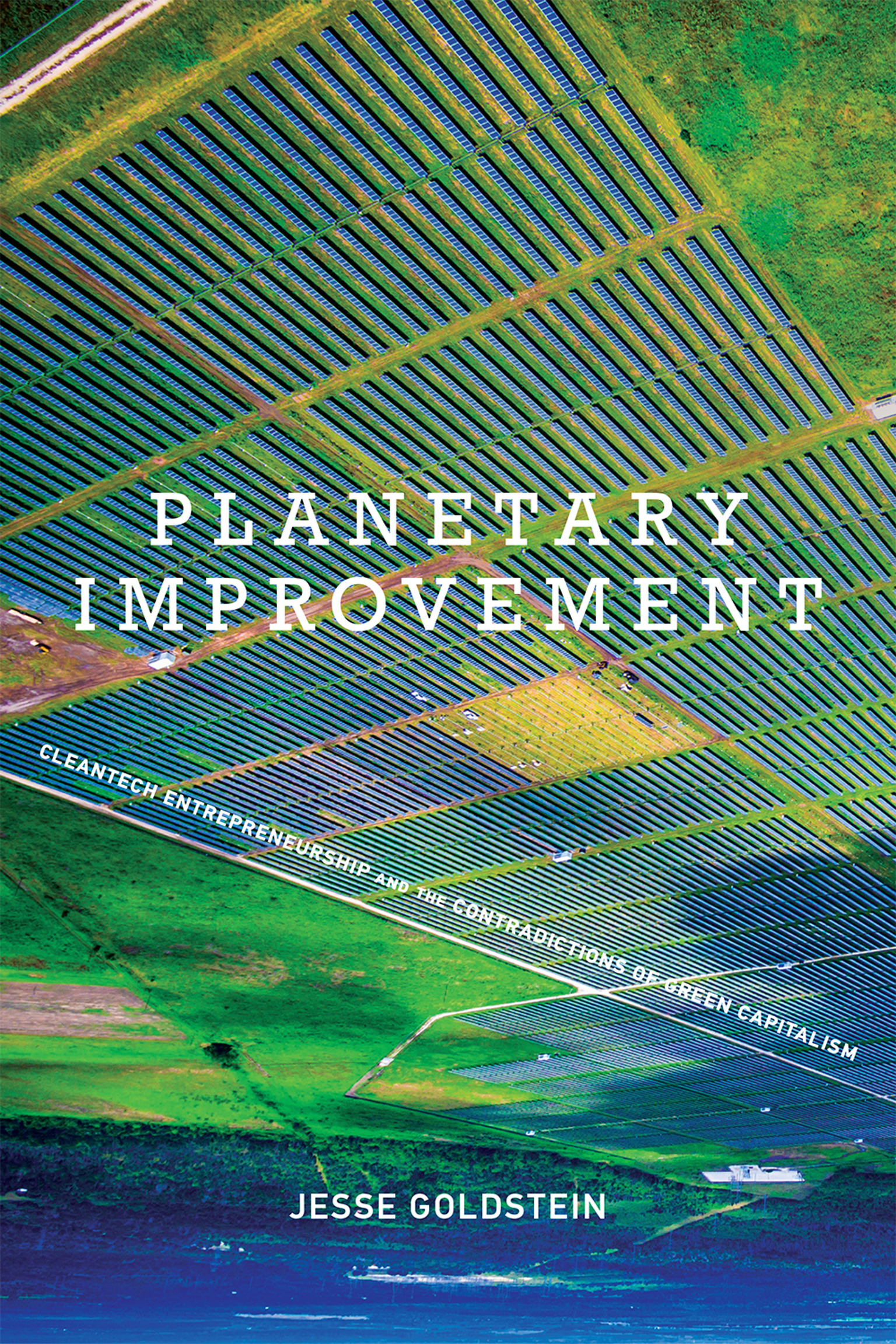
Planetary Improvement An examination of clean technology entrepreneurship finds that “green capitalism” is more capitalist than green. Entrepreneurs and investors in the green economy have encouraged a vision of addressing climate change with new technologies. In Planetary Improvement, Jesse Goldstein examines the cleantech entrepreneurial community in order to understand the limitations of environmental transformation within a capitalist system. Reporting on a series of investment pitches by cleantech entrepreneurs in New York City, Goldstein describes investor-friendly visions of incremental improvements to the industrial status quo that are hardly transformational. He explores a new “green spirit of capitalism,” a discourse of planetary improvement, that aims to “save the planet” by looking for “non-disruptive disruptions,” technologies that deliver “solutions” without changing much of what causes the underlying problems in the first place. Goldstein charts the rise of business environmentalism over the last half of the twentieth century and examines cleantech's unspoken assumptions of continuing cheap and abundant energy. Recounting the sometimes conflicting motivations of cleantech entrepreneurs and investors, he argues that the cleantech innovation ecosystem and its Schumpetarian dynamic of creative destruction are built around attempts to control creativity by demanding that transformational aspirations give way to short-term financial concerns. As a result, capitalist imperatives capture and stifle visions of sociotechnical possibility and transformation. Finally, he calls for a green spirit that goes beyond capitalism, in which sociotechnical experimentation is able to break free from the narrow bonds and relative privilege of cleantech entrepreneurs and the investors that control their fate. POLITICAL SCIENCE,Public Policy,Environmental Policy
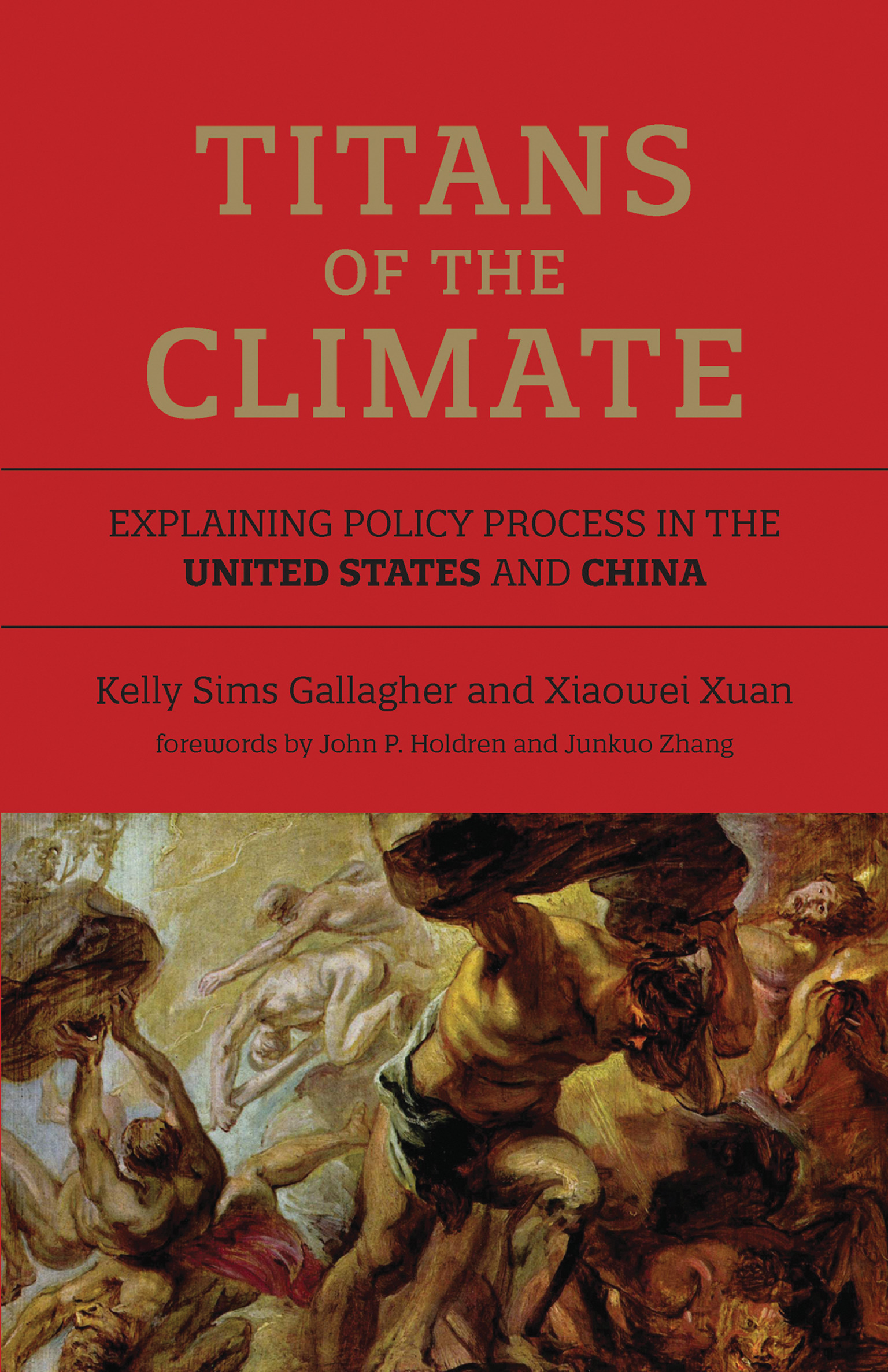
Titans of the Climate How the planet's two largest greenhouse gas emitters navigate climate policy. The United States and China together account for a disproportionate 45 percent of global carbon dioxide emissions. In 2014, then-President Obama and Chinese President Xi Jinping announced complementary efforts to limit emissions, paving the way for the Paris Agreement. And yet, with President Trump's planned withdrawal from the Paris accords and Xi's consolidation of power—as well as mutual mistrust fueled by misunderstanding—the climate future is uncertain. In Titans of the Climate, Kelly Sims Gallagher and Xiaowei Xuan examine how the planet's two largest greenhouse gas emitters develop and implement climate policy. Through dispassionate analysis, the authors aim to help readers understand the challenges, constraints, and opportunities in each country. Gallagher—a former U.S. climate policymaker—and Xuan—a member of a Chinese policy think tank—describe the specific drivers—political, economic, and social—of climate policies in both countries and map the differences between policy outcomes. They characterize the U.S. approach as “deliberative incrementalism”; the Chinese, meanwhile, engage in “strategic pragmatism.” Comparing the policy processes of the two countries, Gallagher and Xuan make the case that if each country understands more about the other's goals and constraints, climate policy cooperation is more likely to succeed. POLITICAL SCIENCE,Public Policy,Environmental Policy
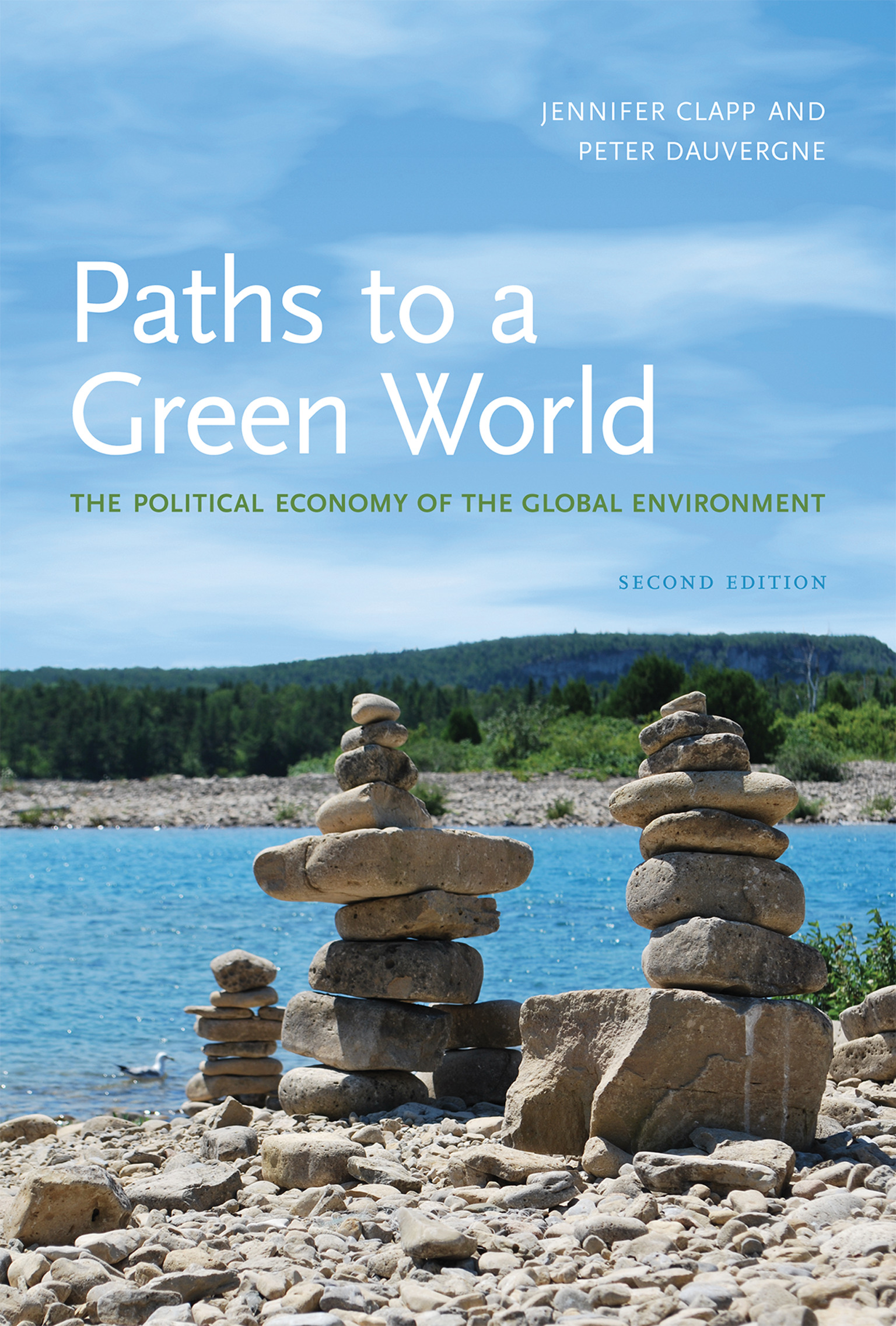
Paths to a Green World, second edition A new edition of a book that takes a comprehensive look at the ways economic processes affect global environmental outcomes. This comprehensive and accessible book fills the need for a political economy view of global environmental politics, focusing on the ways international economic processes affect environmental outcomes. It examines the main actors and forces shaping global environmental management, particularly in the developing world. Moving beyond the usual emphasis on international agreements and institutions, it strives to capture not only academic theoretical debates but also views on politics, economics, and the environment within the halls of global conferences, on the streets during antiglobalization protests, and in the boardrooms of international agencies, nongovernmental organizations, and industry associations. The book maps out an original typology of four contrasting worldviews of environmental change—those of market liberals, institutionalists, bioenvironmentalists, and social greens—and uses them as a framework to examine the links between the global political economy and ecological change. This typology provides a common language for students, instructors, and scholars to discuss the issues across the classical social science divisions.The second edition of this popular text has been thoroughly revised and updated to reflect recent events, including the food crisis of 2007-2008, the financial meltdown of 2008, and the Copenhagen Climate Conference of 2009. Topics covered include the environmental implications of globalization; wealth, poverty, and consumption; global trade; transnational corporations; and multilateral and private finance. POLITICAL SCIENCE,Public Policy,Environmental Policy
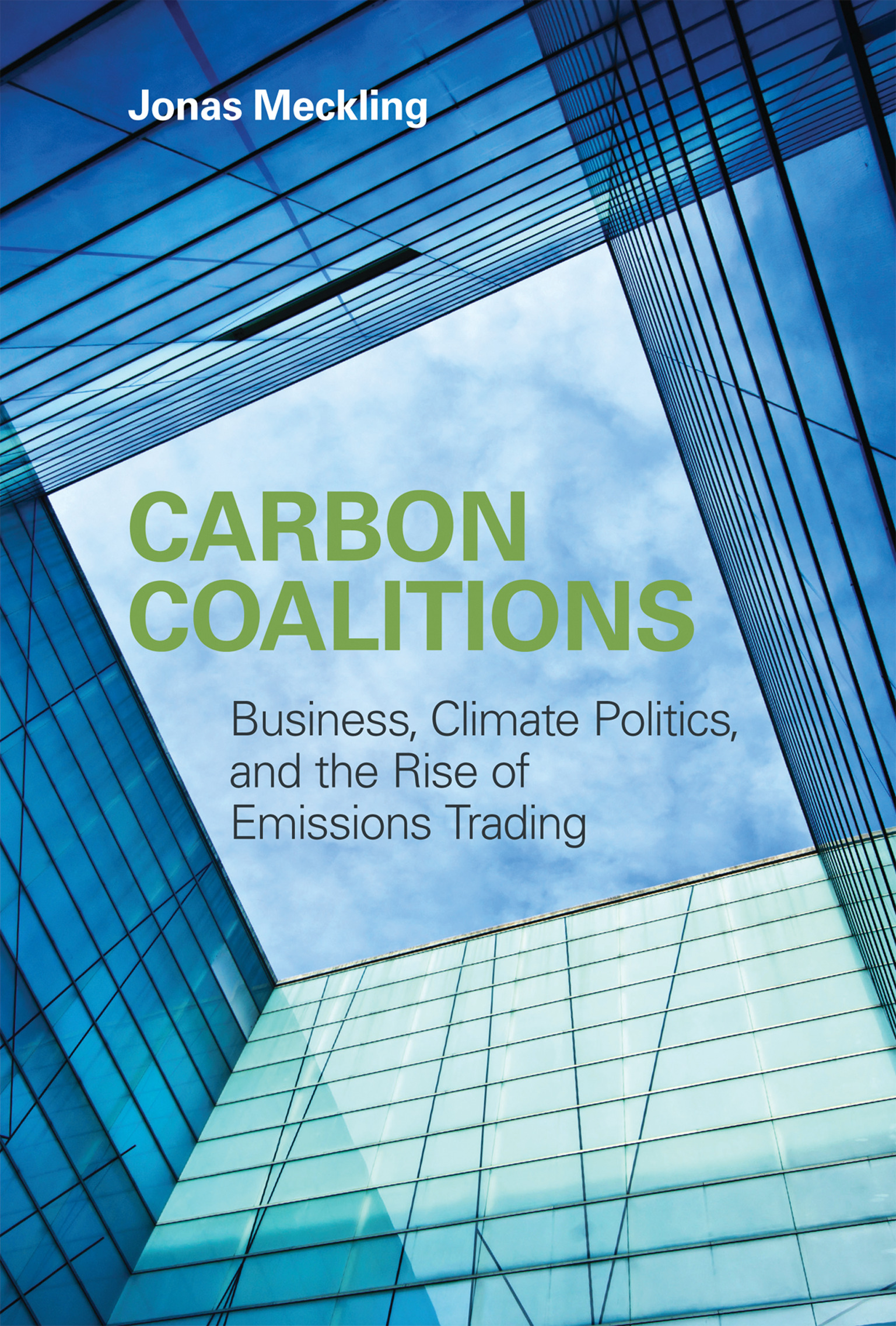
Carbon Coalitions An examination of how a transnational coalition of firms and NGOs influenced the emergence of emissions trading as a central component of global climate governance. Over the past decade, carbon trading has emerged as the industrialized world's primary policy response to global climate change despite considerable controversy. With carbon markets worth $144 billion in 2009, carbon trading represents the largest manifestation of the trend toward market-based environmental governance. In Carbon Coalitions, Jonas Meckling presents the first comprehensive study on the rise of carbon trading and the role business played in making this policy instrument a central pillar of global climate governance. Meckling explains how a transnational coalition of firms and a few market-oriented environmental groups actively promoted international emissions trading as a compromise policy solution in a situation of political stalemate. The coalition sidelined not only environmental groups that favored taxation and command-and-control regulation but also business interests that rejected any emissions controls. Considering the sources of business influence, Meckling emphasizes the importance of political opportunities (policy crises and norms), coalition resources (funding and legitimacy,) and political strategy (mobilizing state allies and multilevel advocacy). Meckling presents three case studies that represent milestones in the rise of carbon trading: the internationalization of emissions trading in the Kyoto Protocol (1989–2000); the creation of the EU Emissions Trading System (1998–2008); and the reemergence of emissions trading on the U.S. policy agenda (2001–2009). These cases and the theoretical framework that Meckling develops for understanding the influence of transnational business coalitions offer critical insights into the role of business in the emergence of market-based global environmental governance. POLITICAL SCIENCE,Public Policy,Environmental Policy
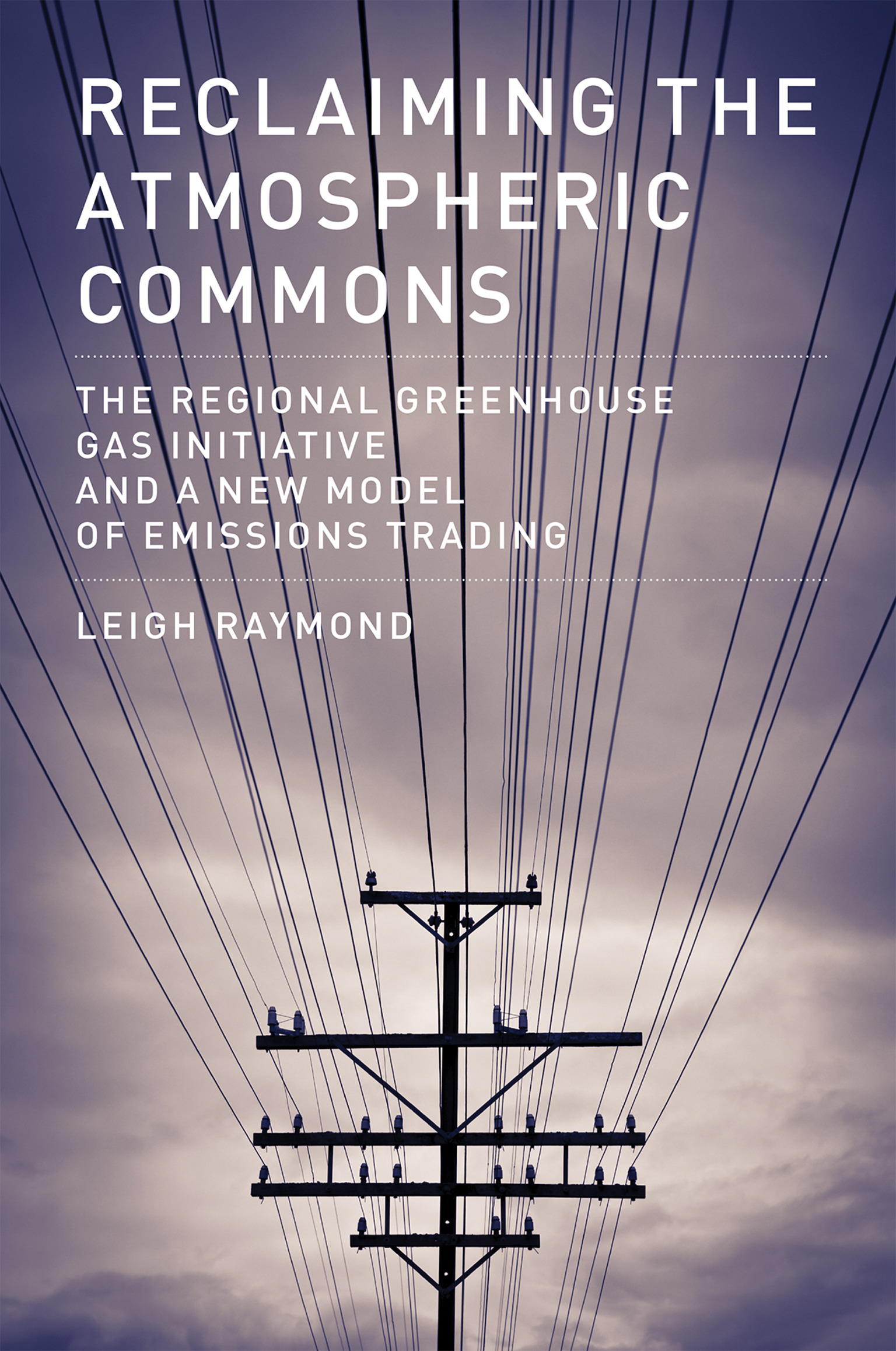
Reclaiming the Atmospheric Commons How the Regional Greenhouse Gas Initiative created a new paradigm in climate policy by requiring polluters to pay for their emissions for the first time. In 2008, a group of states in the northeast United States launched an emissions trading program, the Regional Greenhouse Gas Initiative (RGGI). With RGGI, these states—Connecticut, Delaware, Maine, Maryland, Massachusetts, New Hampshire, New Jersey, New York, Rhode Island, and Vermont—achieved what had been considered politically impossible: they forced polluters to pay the public for their emissions. The states accomplished this by conducting auctions of emissions “allowances”; by 2014, they had raised more than $2.2 billion in revenues. In this first in-depth examination of RGGI, Leigh Raymond describes this revolutionary and influential policy model and explains the practical and theoretical implications for climate policy. Other cap-and-trade schemes had been criticized for providing private profits rather than public benefits, allowing private firms to make money by buying and selling valuable “rights to pollute.” RGGI, by contrast, directed virtually all emissions auction revenues to programs benefiting the public at large. By reframing the issue in terms of public benefits, environmental advocates emphasized the public ownership of the atmospheric commons and private corporations' responsibility to pay for their use of it. Raymond argues that this kind of “normative reframing” is significant not only for environmental policy making but also for theories of the policy process, helping to explain and predict sudden policy change. POLITICAL SCIENCE,Public Policy,Environmental Policy
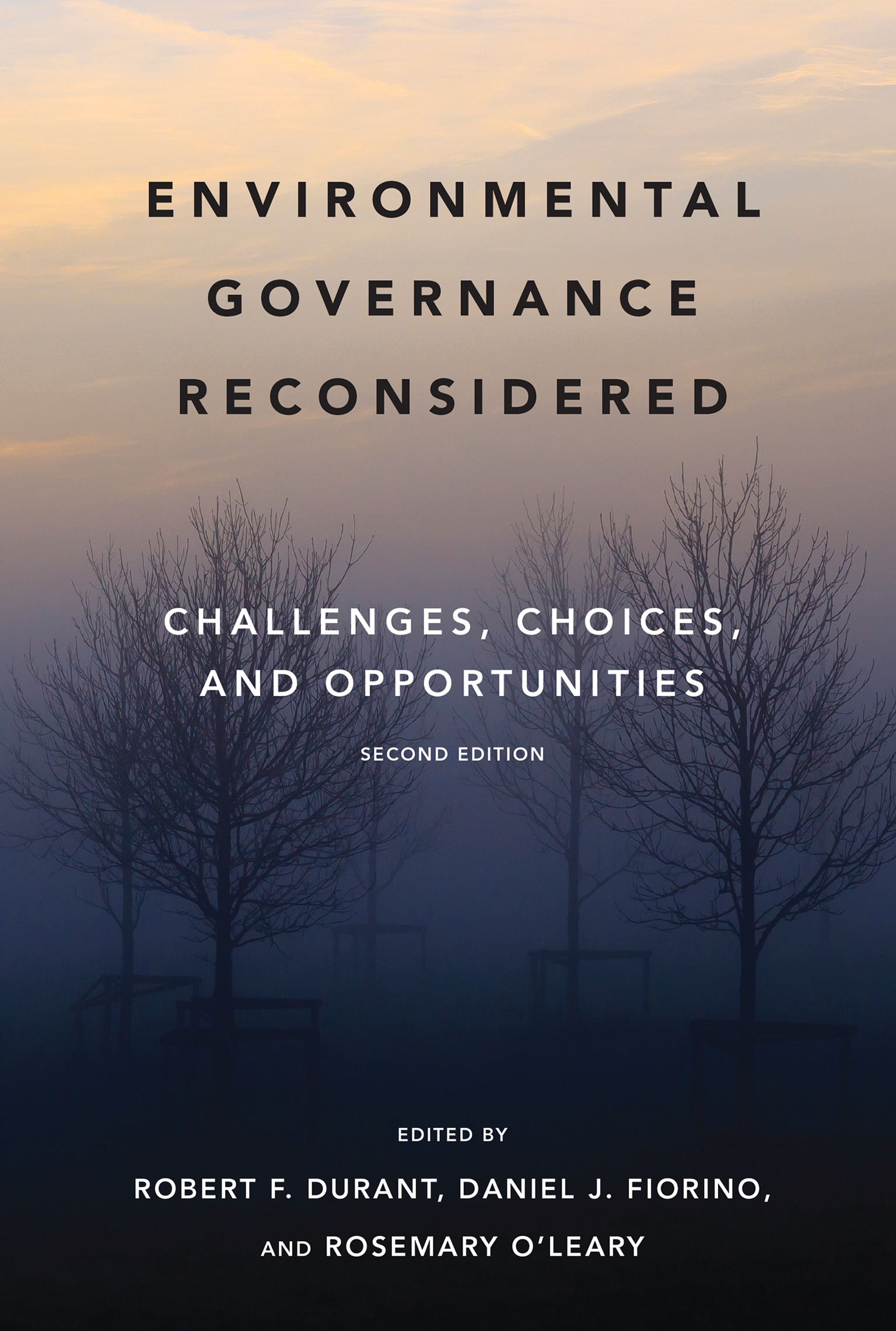
Environmental Governance Reconsidered, second edition Key topics in the ongoing evolution of environmental governance, with new and updated material. This survey of current issues and controversies in environmental policy and management is unique in its thematic mix, broad coverage of key debates, and in-depth analysis. The contributing authors, all distinguished scholars or practitioners, offer a comprehensive examination of key topics in the continuing evolution of environmental governance, with perspectives from public policy, public administration, political science, international relations, sustainability theory, environmental economics, risk analysis, and democratic theory. The second edition of this popular reader has been thoroughly revised, with updated coverage and new topics. The emphasis has shifted from sustainability to include sustainable cities, from domestic civic environmentalism to global civil society, and from global interdependence to the evolution of institutions of global environmental governance. A general focus on devolution of authority in the United States has been sharpened to address the specifics of contested federalism and fracking, and the treatment of flexibility now explores the specifics of regulatory innovation and change. New chapters join original topics such as environmental justice and collaboration and conflict resolution to address highly salient and timely topics: energy security; risk assessment, communication, and technology innovation; regulation-by-revelation; and retrospective regulatory analysis. The topics are organized and integrated by the book's “3R” framework: reconceptualizing governance to reflect ecological risks and interdependencies better, reconnecting with stakeholders, and reframing administrative rationality. Extensive cross-references pull the chapters together. A broad reference list enables readers to pursue topics further. Contributors Regina S. Axelrod, Robert F. Durant, Kirk Emerson, Daniel J. Fiorino, Anne J. Kantel, David M. Konisky, Michael E. Kraft, Jennifer Kuzma, Richard Morgenstern, Tina Nabatchi, Rosemary O'Leary, Barry Rabe, Walter A. Rosenbaum, Stacy D. VanDeveer, Paul Wapner POLITICAL SCIENCE,Public Policy,Environmental Policy
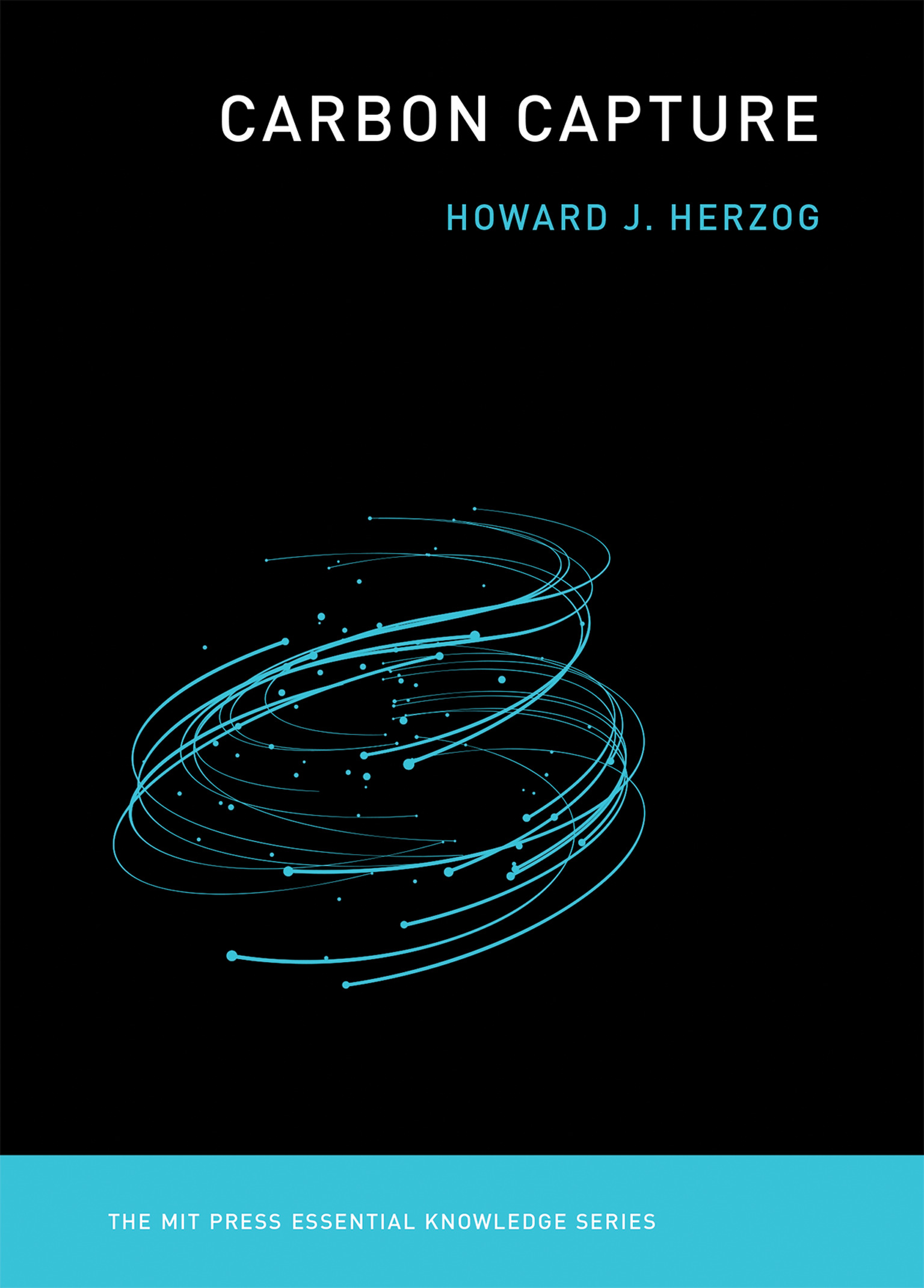
Carbon Capture A concise overview of carbon dioxide capture and storage (CCS), a promising but overlooked climate change mitigation pathway. The burning of fossil fuels releases carbon dioxide (CO2), and these CO2 emissions are a major driver of climate change. Carbon capture offers a path to climate change mitigation that has received relatively little attention. In this volume in the MIT Press Essential Knowledge series, Howard Herzog offers a concise guide to carbon capture, covering basic information as well as the larger context of climate technology and policy. Carbon capture, or carbon dioxide capture and storage (CCS), refers to a suite of technologies that reduce CO2 emissions by “capturing” CO2 before it is released into the atmosphere and then transporting it to where it will be stored or used. It is the only climate change mitigation technique that deals directly with fossil fuels rather than providing alternatives to them. Herzog, a pioneer in carbon capture research, begins by discussing the fundamentals of climate change and how carbon capture can be one of the solutions. He explains capture and storage technologies, including chemical scrubbing and the injection of CO2 deep underground. He reports on current efforts to deploy CCS at factories and power plants and attempts to capture CO2 from the air itself. Finally, he explores the policies and politics in play around CCS and argues for elevating carbon capture in the policy agenda. POLITICAL SCIENCE,Public Policy,Environmental Policy

The Paradox of Scale An examination of why NGOs often experience difficulty creating lasting change, with case studies of transnational conservation organizations in Southeast Asia and the Pacific. Why do nongovernmental organizations face difficulty creating lasting change? How can they be more effective? In this book, Cristina Balboa examines NGO authority, capacity, and accountability to propose that a “paradox of scale” is a primary barrier to NGO effectiveness. This paradox—when what gives an NGO authority on one scale also weakens its authority on another scale—helps explain how NGOs can be seen as an authority on particular causes on a global scale, but then fail to effect change at the local level. Drawing on case studies of transnational conservation organizations in Southeast Asia and the Pacific, The Paradox of Scale explores how NGOs build, maintain, and lose authority over time. Balboa sets a new research agenda for the study of governance, offering practical concepts and analysis to help NGO practitioners. She introduces the concept of authority as a form of legitimated power, explaining why it is necessary for NGOs to build authority at multiple scales when they create, implement, or enforce rules. Examining the experiences of Conservation International in Papua New Guinea, International Marinelife Alliance in the Philippines, and the Community Conservation Network in Palau, Balboa explains how a paradox of scale can develop even for those NGOs that seem powerful and effective. Interdisciplinary in its approach, The Paradox of Scale offers guidance for interpreting the actions and pressures accompanying work with NGOs, showing why even the most authoritative NGOs often struggle to make a lasting impact. POLITICAL SCIENCE,Public Policy,Environmental Policy
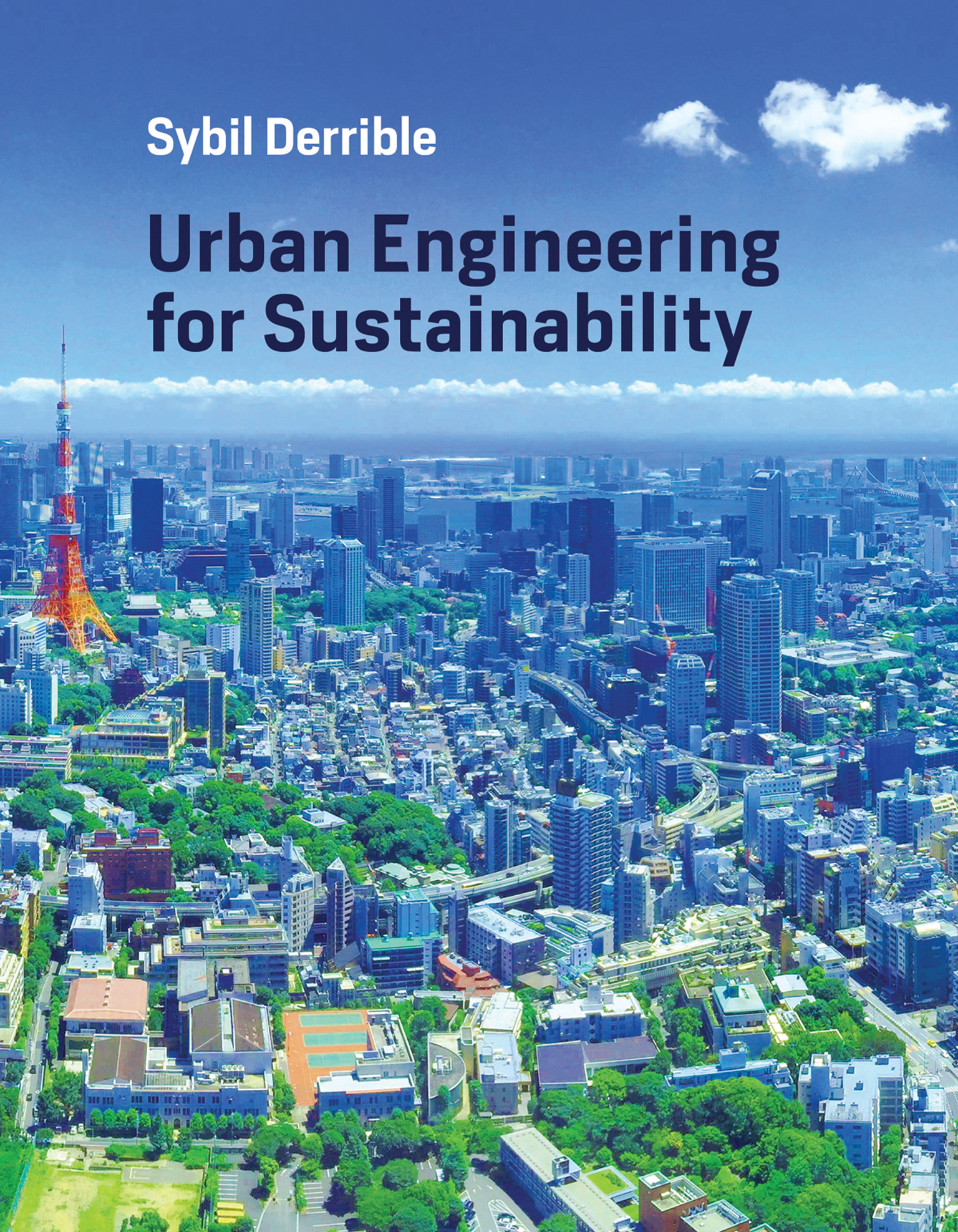
Urban Engineering for Sustainability A textbook that introduces integrated, sustainable design of urban infrastructures, drawing on civil engineering, environmental engineering, urban planning, electrical engineering, mechanical engineering, and computer science. This textbook introduces urban infrastructure from an engineering perspective, with an emphasis on sustainability. Bringing together both fundamental principles and practical knowledge from civil engineering, environmental engineering, urban planning, electrical engineering, mechanical engineering, and computer science, the book transcends disciplinary boundaries by viewing urban infrastructures as integrated networks. The text devotes a chapter to each of five engineering systems—electricity, water, transportation, buildings, and solid waste—covering such topics as fundamentals, demand, management, technology, and analytical models. Other chapters present a formal definition of sustainability; discuss population forecasting techniques; offer a history of urban planning, from the Neolithic era to Kevin Lynch and Jane Jacobs; define and discuss urban metabolism and infrastructure integration, reviewing system interdependencies; and describe approaches to urban design that draw on complexity theory, algorithmic models, and machine learning. Throughout, a hypothetical city state, Civitas, is used to explain and illustrate the concepts covered. Each chapter includes working examples and problem sets. An appendix offers tables, diagrams, and conversion factors. The book can be used in advanced undergraduate and graduate courses in civil engineering and as a reference for practitioners. It can also be helpful in preparation for the Fundamentals of Engineering (FE) and Principles and Practice of Engineering (PE) exams. POLITICAL SCIENCE,Public Policy,Environmental Policy
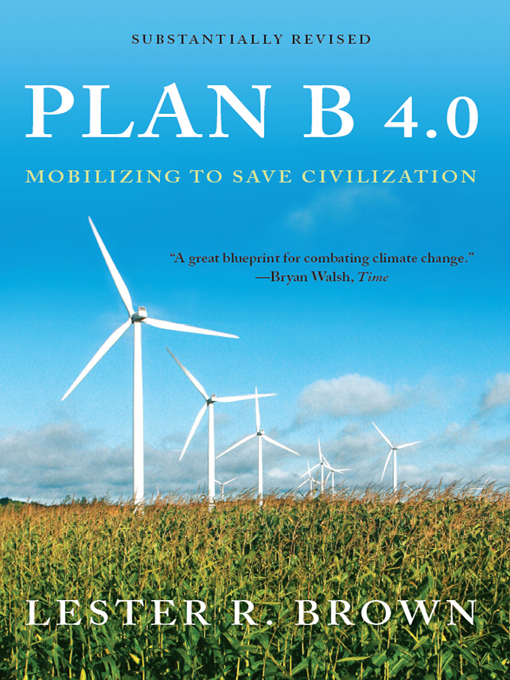
Plan B 4.0 “[Brown’s] ability to make a complicated subject accessible to the general reader is remarkable.â€â€”Katherine Salant, Washington Post As fossil fuel prices rise, oil insecurity deepens, and concerns about climate change cast a shadow over the future of coal, a new energy economy is emerging. Wind, solar, and geothermal energy are replacing oil, coal, and natural gas, at a pace and on a scale we could not have imagined even a year ago. For the first time since the Industrial Revolution, we have begun investing in energy sources that can last forever. Plan B 4.0 explores both the nature of this transition to a new energy economy and how it will affect our daily lives. POLITICAL SCIENCE,Public Policy,Environmental Policy
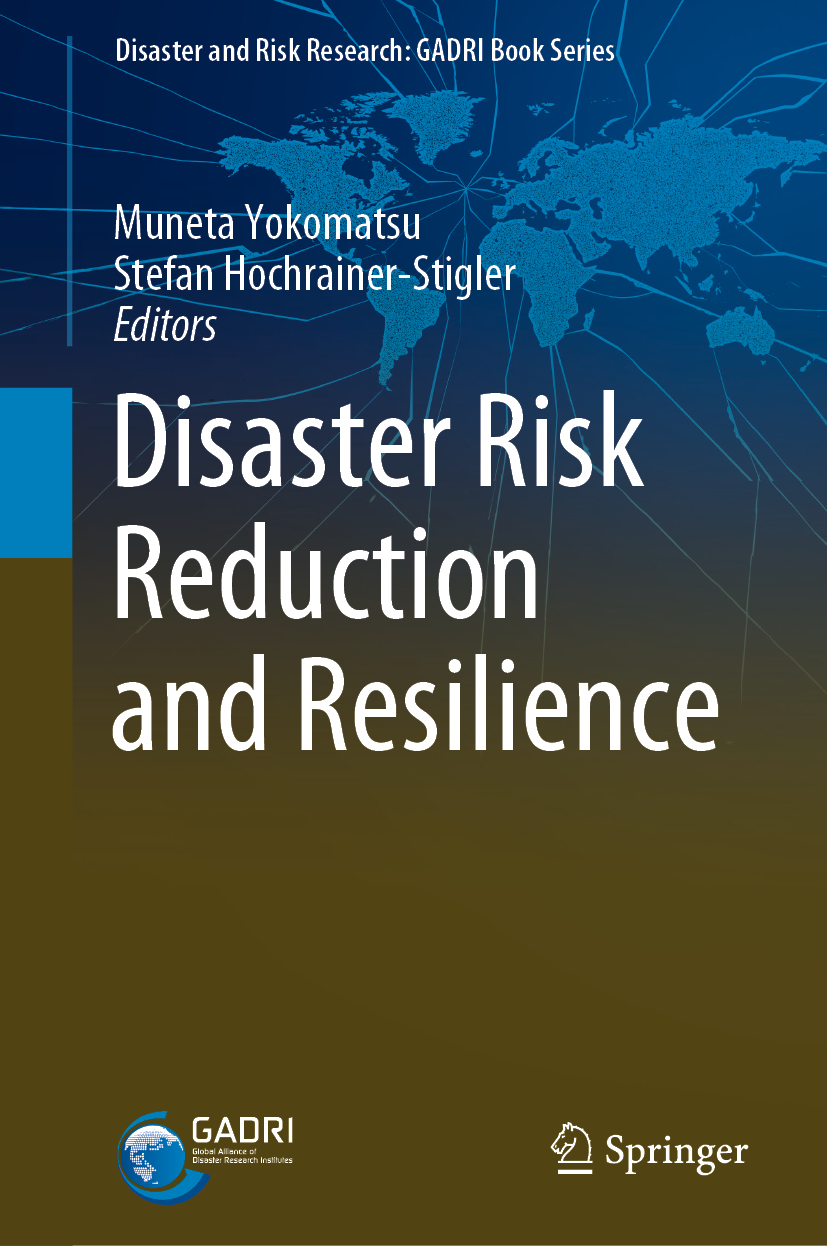
Disaster Risk Reduction and Resilience This book provides insight on how disaster risk management can increase the resilience of society to various natural hazards. The multi-dimensionality of resilience and the various different perspectives in regards to disaster risk reduction are taken explicitly into account by providing studies and approaches on different scales and ranging from natural science based methods to social science frameworks. For all chapters, special emphasis is placed on implementation aspects and specifically in regards to the targets and priorities for action laid out in the Sendai Framework for Disaster Risk Reduction. The chapters provide also a starting point for interested readers on specific issues of resilience and therefore include extensive reference material and important future directions for research. POLITICAL SCIENCE,Public Policy,Environmental Policy
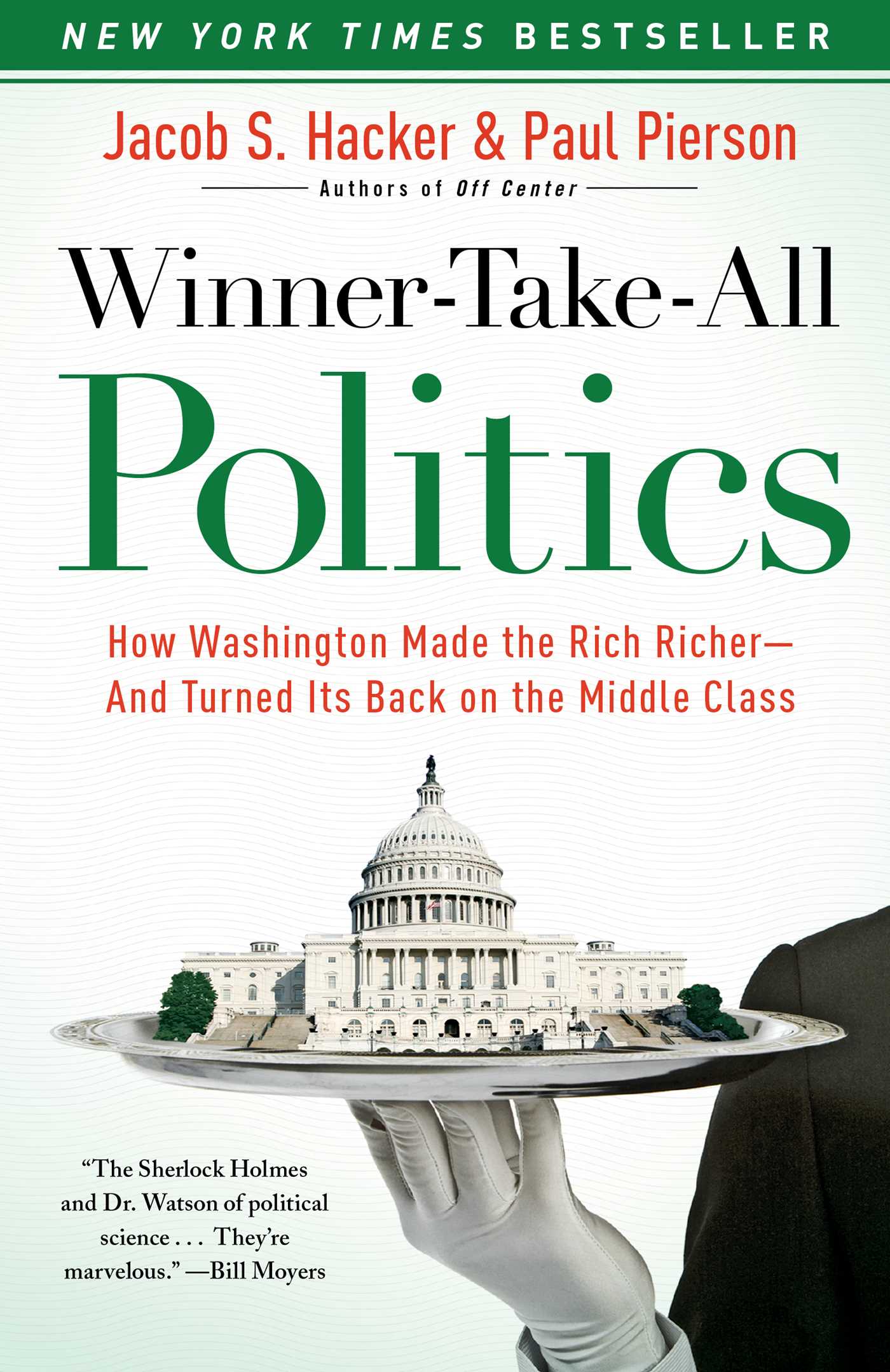
Winner-Take-All Politics A groundbreaking work that identifies the real culprit behind one of the great economic crimes of our time— the growing inequality of incomes between the vast majority of Americans and the richest of the rich. We all know that the very rich have gotten a lot richer these past few decades while most Americans haven’t. In fact, the exorbitantly paid have continued to thrive during the current economic crisis, even as the rest of Americans have continued to fall behind. Why do the “haveit- alls†have so much more? And how have they managed to restructure the economy to reap the lion’s share of the gains and shift the costs of their new economic playground downward, tearing new holes in the safety net and saddling all of us with increased debt and risk? Lots of so-called experts claim to have solved this great mystery, but no one has really gotten to the bottom of it—until now. In their lively and provocative Winner-Take-All Politics, renowned political scientists Jacob S. Hacker and Paul Pierson demonstrate convincingly that the usual suspects—foreign trade and financial globalization, technological changes in the workplace, increased education at the top—are largely innocent of the charges against them. Instead, they indict an unlikely suspect and take us on an entertaining tour of the mountain of evidence against the culprit. The guilty party is American politics. Runaway inequality and the present economic crisis reflect what government has done to aid the rich and what it has not done to safeguard the interests of the middle class. The winner-take-all economy is primarily a result of winner-take-all politics. In an innovative historical departure, Hacker and Pierson trace the rise of the winner-take-all economy back to the late 1970s when, under a Democratic president and a Democratic Congress, a major transformation of American politics occurred. With big business and conservative ideologues organizing themselves to undo the regulations and progressive tax policies that had helped ensure a fair distribution of economic rewards, deregulation got under way, taxes were cut for the wealthiest, and business decisively defeated labor in Washington. And this transformation continued under Reagan and the Bushes as well as under Clinton, with both parties catering to the interests of those at the very top. Hacker and Pierson’s gripping narration of the epic battles waged during President Obama’s first two years in office reveals an unpleasant but catalyzing truth: winner-take-all politics, while under challenge, is still very much with us. Winner-Take-All Politics—part revelatory history, part political analysis, part intellectual journey— shows how a political system that traditionally has been responsive to the interests of the middle class has been hijacked by the superrich. In doing so, it not only changes how we think about American politics, but also points the way to rebuilding a democracy that serves the interests of the many rather than just those of the wealthy few. POLITICAL SCIENCE,Public Policy,General

Disarmed More than any other advanced industrial democracy, the United States is besieged by firearms violence. Each year, some 30,000 people die by gunfire. Over the course of its history, the nation has witnessed the murders of beloved public figures; massacres in workplaces and schools; and epidemics of gun violence that terrorize neighborhoods and claim tens of thousands of lives. Commanding majorities of Americans voice support for stricter controls on firearms. Yet they have never mounted a true national movement for gun control. Why? Disarmed unravels this paradox. Based on historical archives, interviews, and original survey evidence, Kristin Goss suggests that the gun control campaign has been stymied by a combination of factors, including the inability to secure patronage resources, the difficulties in articulating a message that would resonate with supporters, and strategic decisions made in the name of effective policy. The power of the so-called gun lobby has played an important role in hobbling the gun-control campaign, but that is not the entire story. Instead of pursuing a strategy of incremental change on the local and state levels, gun control advocates have sought national policies. Some 40% of state gun control laws predate the 1970s, and the gun lobby has systematically weakened even these longstanding restrictions. A compelling and engagingly written look at one of America's most divisive political issues, Disarmed illuminates the organizational, historical, and policy-related factors that constrain mass mobilization, and brings into sharp relief the agonizing dilemmas faced by advocates of gun control and other issues in the United States. POLITICAL SCIENCE,Public Policy,General
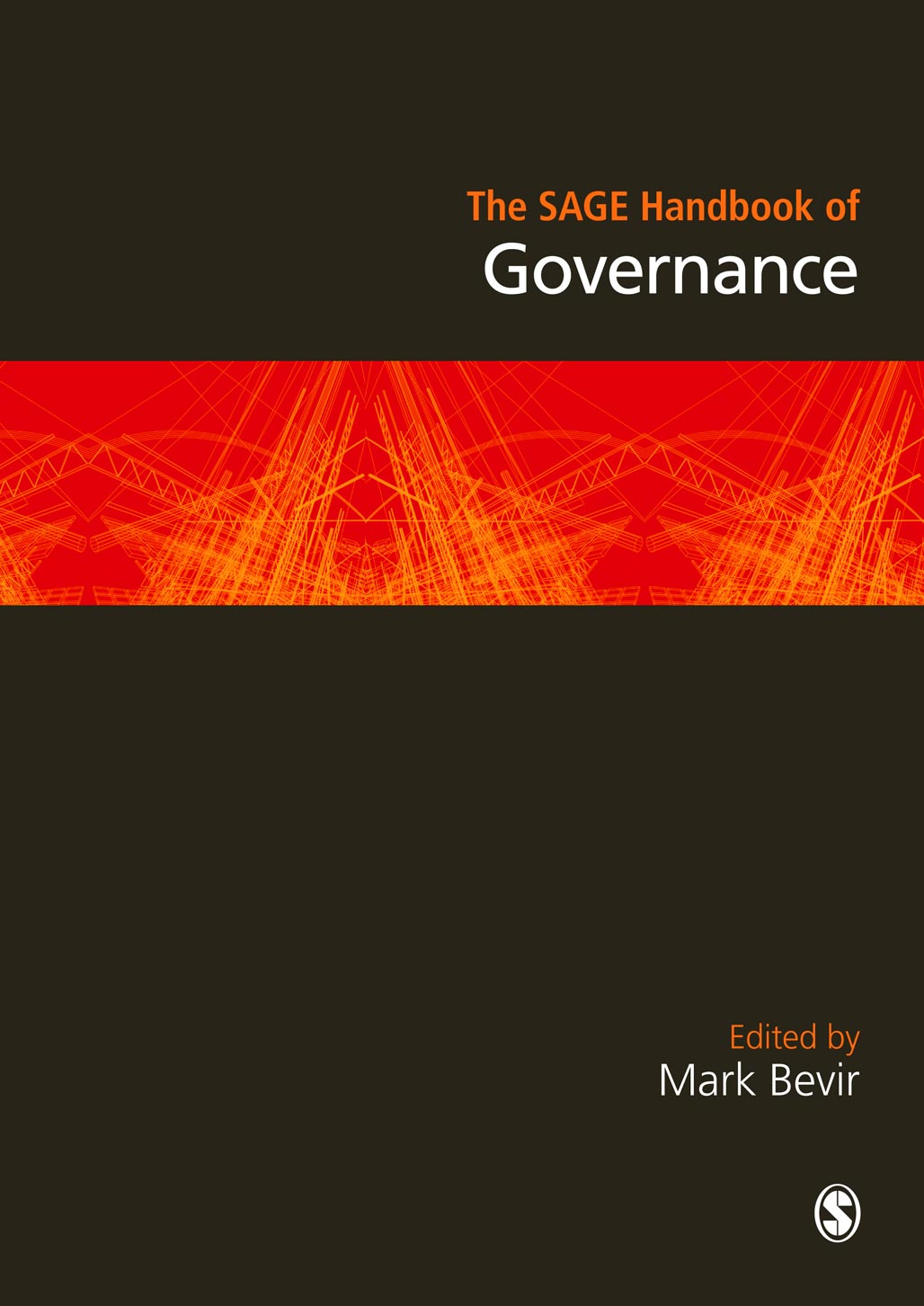
The SAGE Handbook of Governance With chapters from an internationally renowned set of scholars, this is the first Handbook to examine this vibrant and developing field. POLITICAL SCIENCE,Public Policy,General
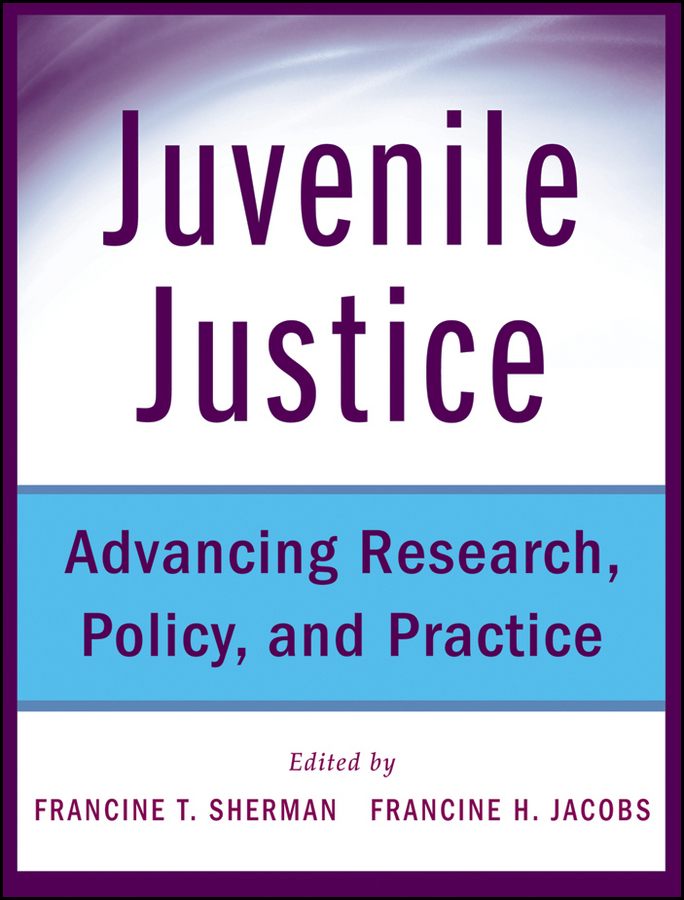
Juvenile Justice "The lessons in this book remind us that we can—and that we must—do better, for the sake of our children, their futures, and the sake of our nation. . . . This volume is a call to action, and I encourage everyone who reads it to take steps to ensure that all America's children are given an equal chance to succeed. We must all work together to replace the cradle-to-prison pipeline with a pipeline to responsible, productive adulthood." —From the Foreword by Marian Wright Edelman, JD, President and founder, Children's Defense Fund, Washington, DC "Juvenile Justice: Advancing Research, Policy, and Practice appears at a critical time, when promising juvenile justice reforms are underway in so many jurisdictions across the United States. Sherman and Jacobs, and their impressive array of expert authors, fill a significant gap in the literature, making the current body of juvenile justice research and experience accessible to policy makers, researchers, and funders, and doing so through a practical and positive lens." —Patrick McCarthy, President and Chief Executive Officer, Annie E. Casey Foundation, Baltimore, MD "Most people have narrow views of what it means to be a delinquent youth. In Juvenile Justice: Advancing Research, Policy, and Practice, Sherman and Jacobs have diligently collected essays from the top experts in the juvenile justice field who tell an empirically based and powerful narrative of who is really in the delinquency system. As this book makes clear, until we ask and answer the right questions, we will remain unable to help the youth most in need." —Alexander Busansky, President, The National Council on Crime and Delinquency, Oakland, CA A comprehensive reference presenting a rehabilitative, youth- and community-centered vision of juvenile justice Juvenile Justice: Advancing Research, Policy, and Practice brings together experts in juvenile justice, child development, and public health to explore the intersections between juvenile justice and needed development of programs and policies that look out for the health and well-being of the youth who enter this system. This timely book provides a usable framework for imagining juvenile justice systems that emphasize the welfare of juveniles, achieved primarily through connections within their communities. A must-read for professionals working in juvenile courts and within juvenile justice agencies, Juvenile Justice: Advancing Research, Policy, and Practice reflects both the considerable advances and the challenges currently evident in the juvenile justice system, with an emphasis on the development and implementation of policies that can succeed in building a new generation of educated young people able to embrace their potential and build successful futures. POLITICAL SCIENCE,Public Policy,General
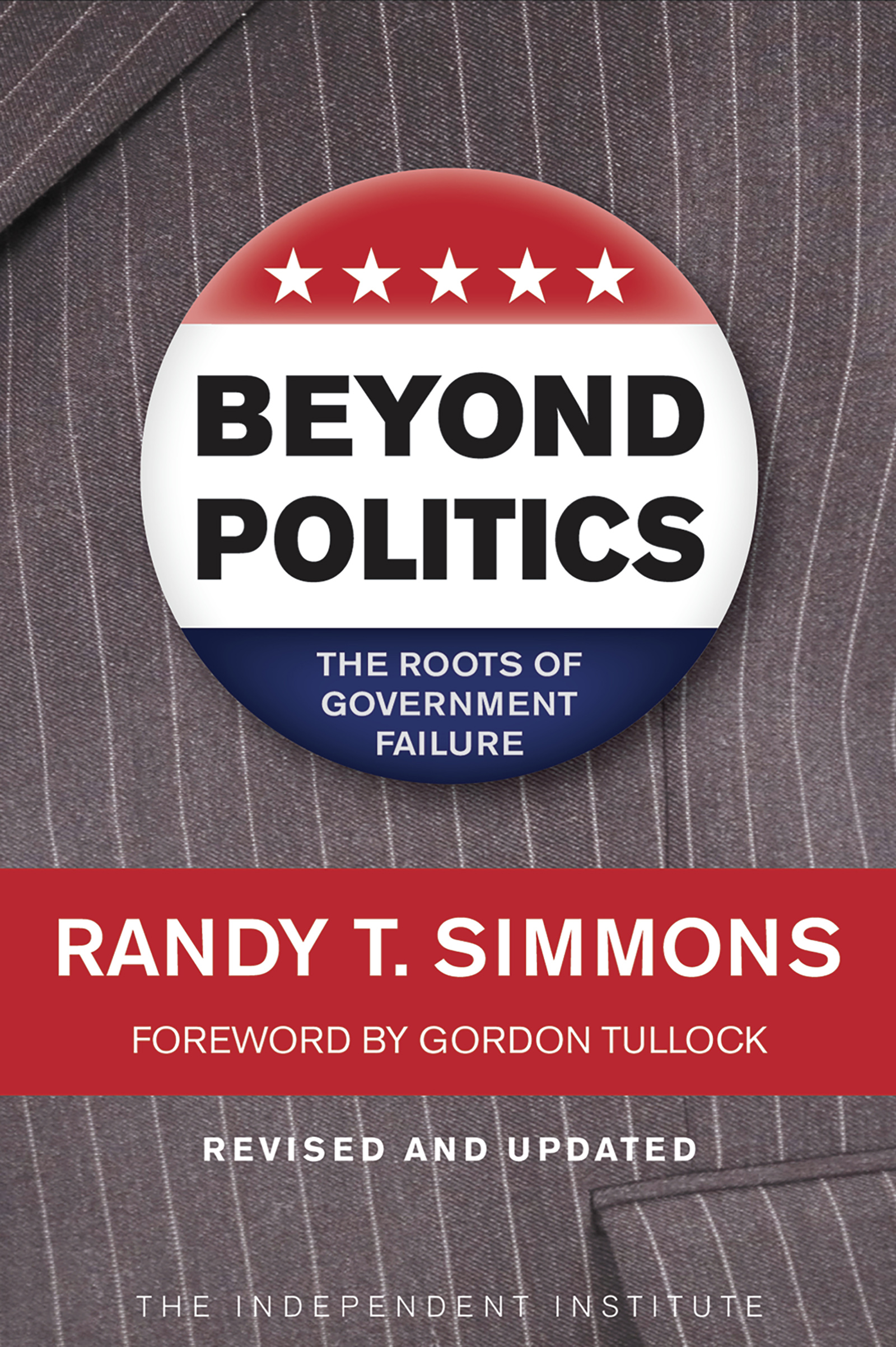
Beyond Politics Providing students of economics, politics, and policy with a concise explanation of public choice, markets, property, and political and economic processes, this record identifies what kinds of actions are beyond the ability of government. Combining public choice with studies of the value of property rights, markets, and institutions, this account produces a much different picture of modern political economy than the one accepted by mainstream political scientists and welfare economists. It demonstrates that when citizens request that their governments do more than it is possible, net benefits are reduced, costs are increased, and wealth and freedom are diminished. Solutions are also suggested with the goal to improve the lot of those who should be the ultimate sovereigns in a democracy: the citizens. POLITICAL SCIENCE,Public Policy,General

Judging Policy Judging Policy analyzes the causes and consequences of the increasingly prominent role courts are being asked to play in the public policy process in Latin America's largest nation, Brazil. POLITICAL SCIENCE,Public Policy,General
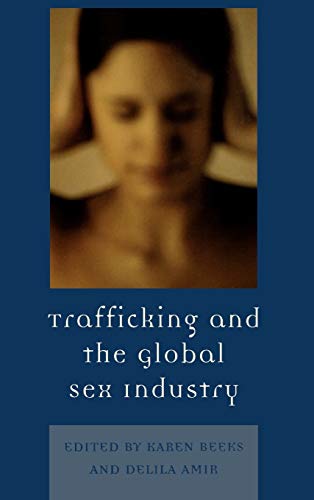
Trafficking & the Global Sex Industry Trafficking & the Global Sex Industry focuses on the international trafficking of women and children for forced labor and prostitution. The essays create a link from country to country, demonstrating the worldwide nature of the problem. Expertly written and well researched, this collection gives the reader a clearer understanding of the problem of human trafficking and the actions being taken to combat it. POLITICAL SCIENCE,Public Policy,General

Property Rights Drawing on the thoughts of various philosophers, political thinkers, economists, and lawyers, Terry Anderson and Laura Huggins present a blueprint for the nonexpert-expert on how societies can encourage or discourage freedom and prosperity through their property rights institutions. This Hoover Classic edition of Property Rightsdetails step-by-step what property rights are, what they do, how they evolve, how they can be protected, and how they promote freedom and prosperity. POLITICAL SCIENCE,Public Policy,General
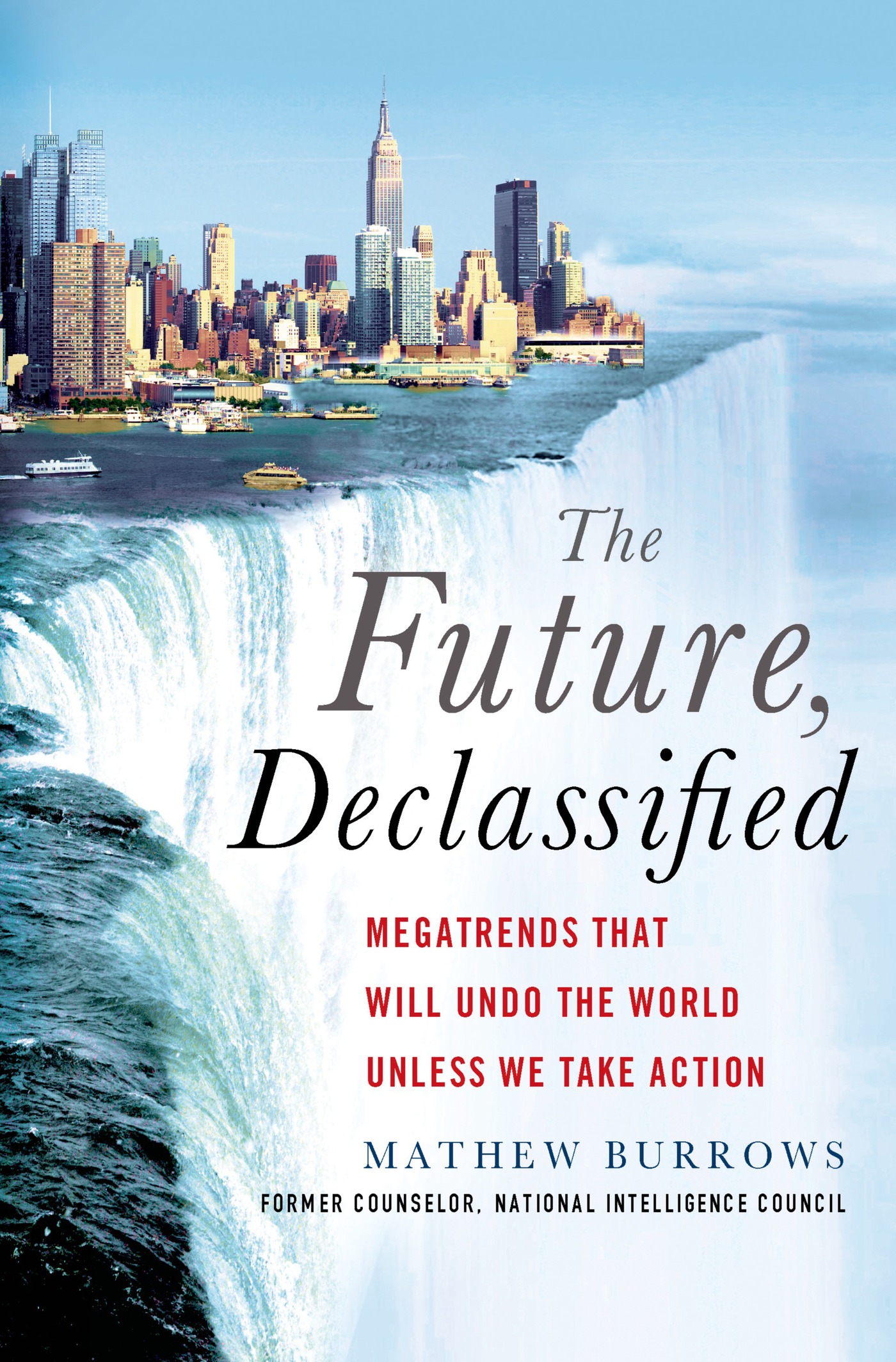
The Future, Declassified In the tradition of Future Shock, a fascinating, optimistic, and frightening look at the world we might inhabit in 2030 POLITICAL SCIENCE,Public Policy,General

Implementing Public Policy Covering the state of the art in the theory and practice of public policy implementation and how this relates to contemporary practice, this Third Edition now further explores issues around researching implementation and the relationship between policy formulation and implementation. POLITICAL SCIENCE,Public Policy,General

Controlling Immigration The third edition of this major work provides a systematic, comparative assessment of the efforts of a selection of major countries, including the U.S., to deal with immigration and immigrant issues— paying particular attention to the ever-widening gap between their migration policy goals and outcomes. Retaining its comprehensive coverage of nations built by immigrants and those with a more recent history of immigration, the new edition pays particular attention to the tensions created by post-colonial immigration, and explores how countries have attempted to control the entry and employment of legal and illegal Third World immigrants, how they cope with the social and economic integration of these new waves of immigrants, and how they deal with forced migration. POLITICAL SCIENCE,Public Policy,General
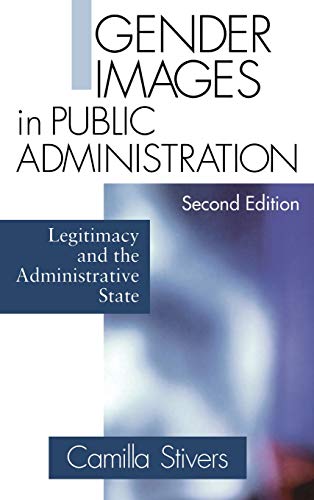
Gender Images in Public Administration Extensively updated to reflect recent research and new theoretical literature, this much-anticipated Second Edition applies a gender lens to the field of public administration, looking at issues of status, power, leadership, legitimacy and change. The author examines the extent of women's historical progress as public employees, their current status in federal, state, and local governments, the peculiar nature of the organizational reality they experience, and women's place in society at large as it is shaped by government. POLITICAL SCIENCE,Public Policy,General

American Contempt for Liberty Throughout history, personal liberty, free markets, and peaceable, voluntary exchanges have been roundly denounced by tyrants and often greeted with suspicion by the general public. Unfortunately, Americans have increasingly accepted the tyrannical ideas of reduced private property rights and reduced rights to profits, and have become enamored with restrictions on personal liberty and control by government. In this latest collection of essays selected from his syndicated newspaper columns, Walter E. Williams takes on a range of controversial issues surrounding race, education, the environment, the Constitution, health care, foreign policy, and more. Skewering the self-righteous and self-important forces throughout society, he makes the case for what he calls the "the moral superiority of personal liberty and its main ingredient—limited government." With his usual straightforward insights and honesty, Williams reveals the loss of liberty in nearly every important aspect of our lives, the massive decline in our values, and the moral tragedy that has befallen Americans today: our belief that it is acceptable for the government to forcibly use one American to serve the purposes of another. POLITICAL SCIENCE,Public Policy,General
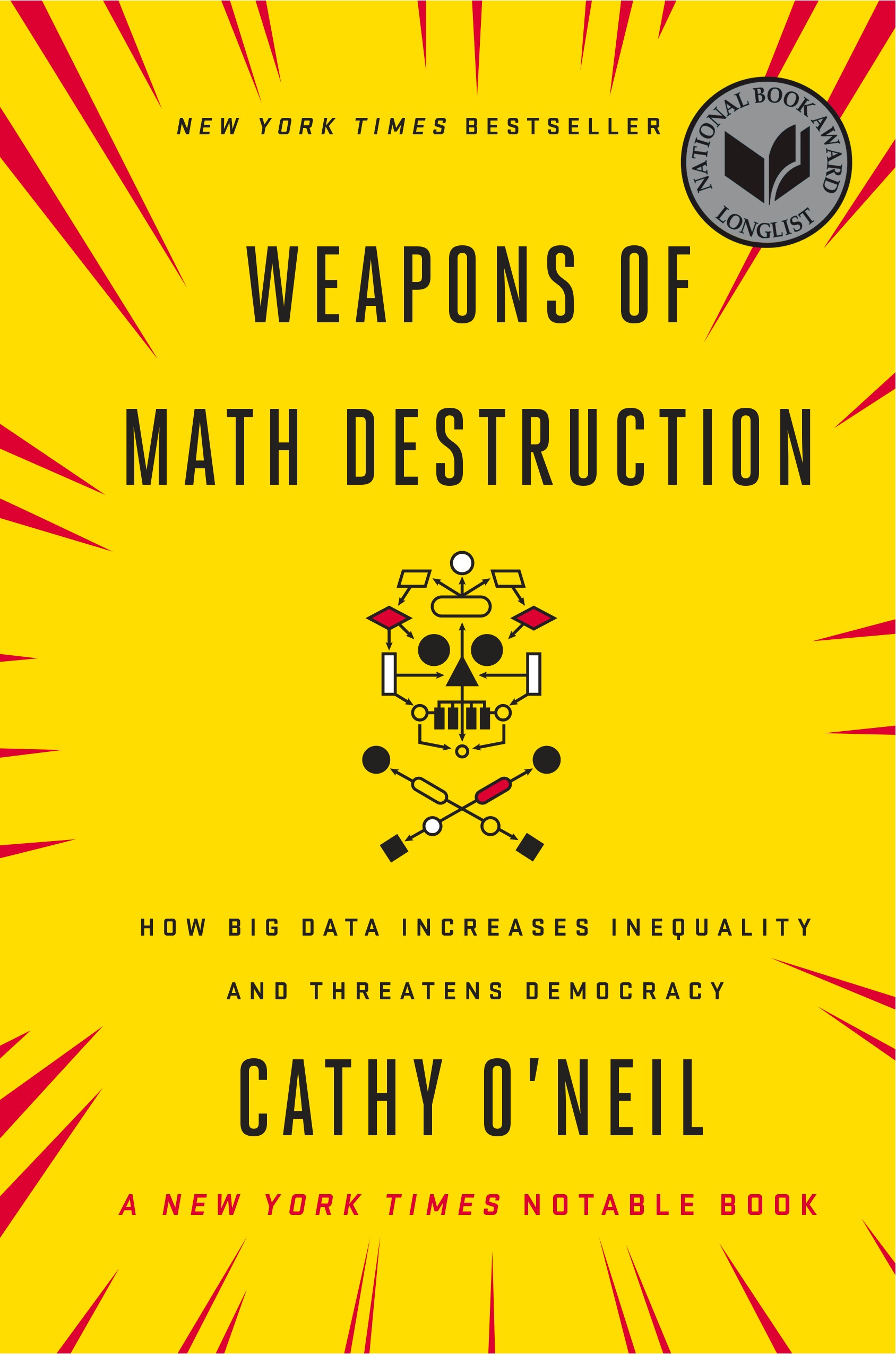
Weapons of Math Destruction NEW YORK TIMES BESTSELLER • A former Wall Street quant sounds the alarm on Big Data and the mathematical models that threaten to rip apart our social fabric—with a new afterword “A manual for the twenty-first-century citizen . . . relevant and urgent.”—Financial Times NATIONAL BOOK AWARD LONGLIST • NAMED ONE OF THE BEST BOOKS OF THE YEAR BY The New York Times Book Review • Boston Globe • Wired • Fortune • Kirkus Reviews • The Guardian • Nature • On Point We live in the age of the algorithm. Increasingly, the decisions that affect our lives—where we go to school, whether we can get a job or a loan, how much we pay for health insurance—are being made not by humans, but by machines. In theory, this should lead to greater fairness: Everyone is judged according to the same rules. But as mathematician and data scientist Cathy O’Neil reveals, the mathematical models being used today are unregulated and uncontestable, even when they’re wrong. Most troubling, they reinforce discrimination—propping up the lucky, punishing the downtrodden, and undermining our democracy in the process. Welcome to the dark side of Big Data. POLITICAL SCIENCE,Public Policy,General
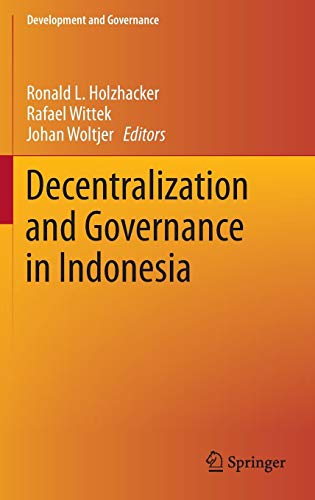
Decentralization and Governance in Indonesia Indonesia over the past two decades has embarked on a process of decentralization as part of a broader process of democratization, which followed earlier periods of centralized governance and authoritarian rule across the archipelago. The purpose of this book is to begin to explore the connections between governance and sustainable society in a wide variety of policy fields in Indonesia, and how reforming governance structures may contribute to societal benefits and the creation of a long-term sustainable society. This book bridges important theoretical debates related to governance and sustainable society and provides empirical research from Indonesia in important policy areas related to this debate. By placing research in different policy areas in a single volume, the link to the broader concepts of governance, decentralization, and societal outcomes is strengthened. The book builds on the recent interest that has focused on Indonesia and the continued development of democracy in the country. The chapters in the book show a rich variety of decentralized governance arrangements and capacity building at the local level in particular. Central standards (for example for social sustainability, anti-corruption arrangements, or for dealing with direct foreign investment), combined with local innovation (for example for municipal coordination of primary health care or metropolitan transport), are key to Indonesia as a country in a continuing process of transformation. We identify three key trends in the on-going process of decentralization and governance in Indonesia. First, we find that formal governance, the relation between the national and local government, is characterized by a system of ‘variable geometry multi-level governance’ depending on the policy area. The challenge ahead is strengthening accountability mechanisms to assure national standards while preserving and encouraging local innovation. Secondly, informal governance mechanisms are evolving to move from ‘hierarchical to network’ forms of governance. Here the challenge is to insure democratic input by citizens and civil society organizations. Finally, we identify a trend toward ‘shared value creation and sustainable cooperation.’ Indonesia is beginning to move from a rather singular policy focus on economic growth to a more complex and developing notion of policymaking for inclusive growth and the creation of a sustainable society for present and future generations. Here the challenge is sound implementation and to increase the effectiveness of governance mechanisms. There is also a noted diffusion of goals, to focus beyond the Jakarta metropolitan area to smaller regional cities, as urbanization continues and rural areas are changing. This book will be of interest for use in advanced undergraduate and graduate courses related to Southeast Asia in the fields of international relations, political science, public administration, economics, law, sociology, education, public health, and the spatial sciences. It will also be of interest to policymakers and government officials at the national and local level in Southeast Asia and middle-income developing countries, officials and policymakers in institutions of regional governance such as the Association of Southeast Asian Nations (ASEAN), and of global governance such as the United Nations and World Bank. It will also be of interest to civil society organizations and other actors focused on policy development and economic development, health, education, the environment, sustainable transport, etc. The book will also be of interest to business people interested in economic and governance issues, such as the management and governance of in-bound foreign investment, inclusive growth, and corporate governance. Finally, the book should be of interest to citizens in advanced, middle-income, and developing countries motivated to learn more about the links between governance and the creation of a sustainable society for current and future generations. POLITICAL SCIENCE,Public Policy,General

Handbook of Global Education Policy This innovative new handbook offers a comprehensive overview of the ways in which domestic education policy is framed and influenced by global institutions and actors. Surveys current debates about the role of education in a global polity, highlights key transnational policy actors, accessibly introduces research methodologies, and outlines global agendas for education reform Includes contributions from an international cast of established and emerging scholars at the forefront of the field thoughtfully edited and organized by a team of world-renowned global education policy experts Each section features a thorough introduction designed to facilitate readers’ understanding of the subsequent material and highlight links to interdisciplinary global policy scholarship Written in an accessible and engaging style that will appeal to domestic and international policy practitioners, social scientists, and education scholars alike POLITICAL SCIENCE,Public Policy,General
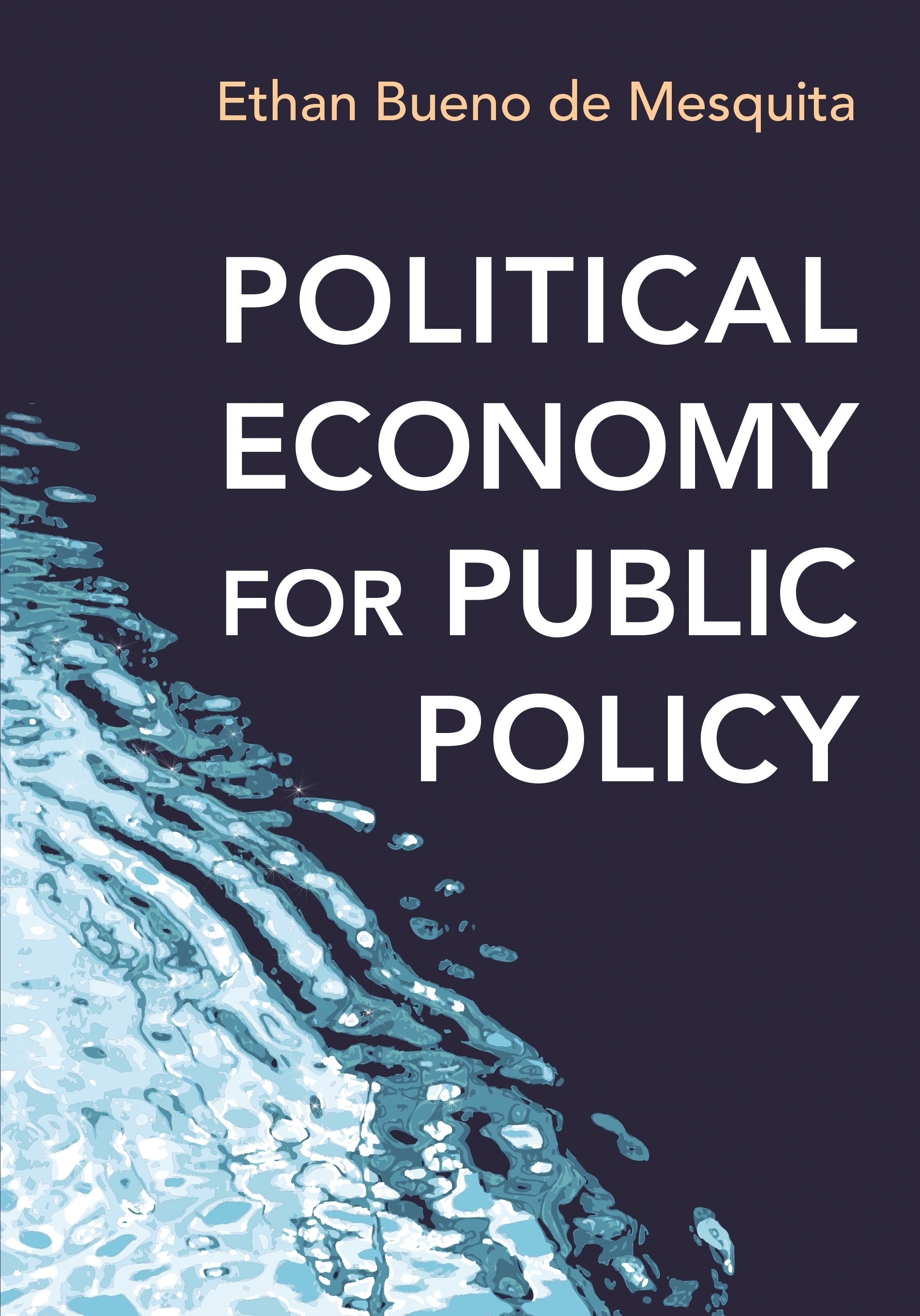
Political Economy for Public Policy The ideal introductory textbook to the politics of the policymaking process This textbook uses modern political economy to introduce students of political science, government, economics, and public policy to the politics of the policymaking process. The book's distinct political economy approach has two virtues. By developing general principles for thinking about policymaking, it can be applied across a range of issue areas. It also unifies the policy curriculum, offering coherence to standard methods for teaching economics and statistics, and drawing connections between fields. The book begins by exploring the normative foundations of policymaking—political theory, social choice theory, and the Paretian and utilitarian underpinnings of policy analysis. It then introduces game theoretic models of social dilemmas—externalities, coordination problems, and commitment problems—that create opportunities for policy to improve social welfare. Finally, it shows how the political process creates technological and incentive constraints on government that shape policy outcomes. Throughout, concepts and models are illustrated and reinforced with discussions of empirical evidence and case studies. This textbook is essential for all students of public policy and for anyone interested in the most current methods influencing policymaking today. Comprehensive approach to politics and policy suitable for advanced undergraduates and graduate students Models unify policy curriculum through methodological coherence Exercises at the end of every chapter Self-contained appendices cover necessary game theory Extensive discussion of cases and applications POLITICAL SCIENCE,Public Policy,General

Comparing Public Policies Updated to examine the most recent political developments, this Second Edition now also includes coverage of European Union politics. The book continues to offer a clear exploration of how politics in a range of areas influence policy. POLITICAL SCIENCE,Public Policy,General
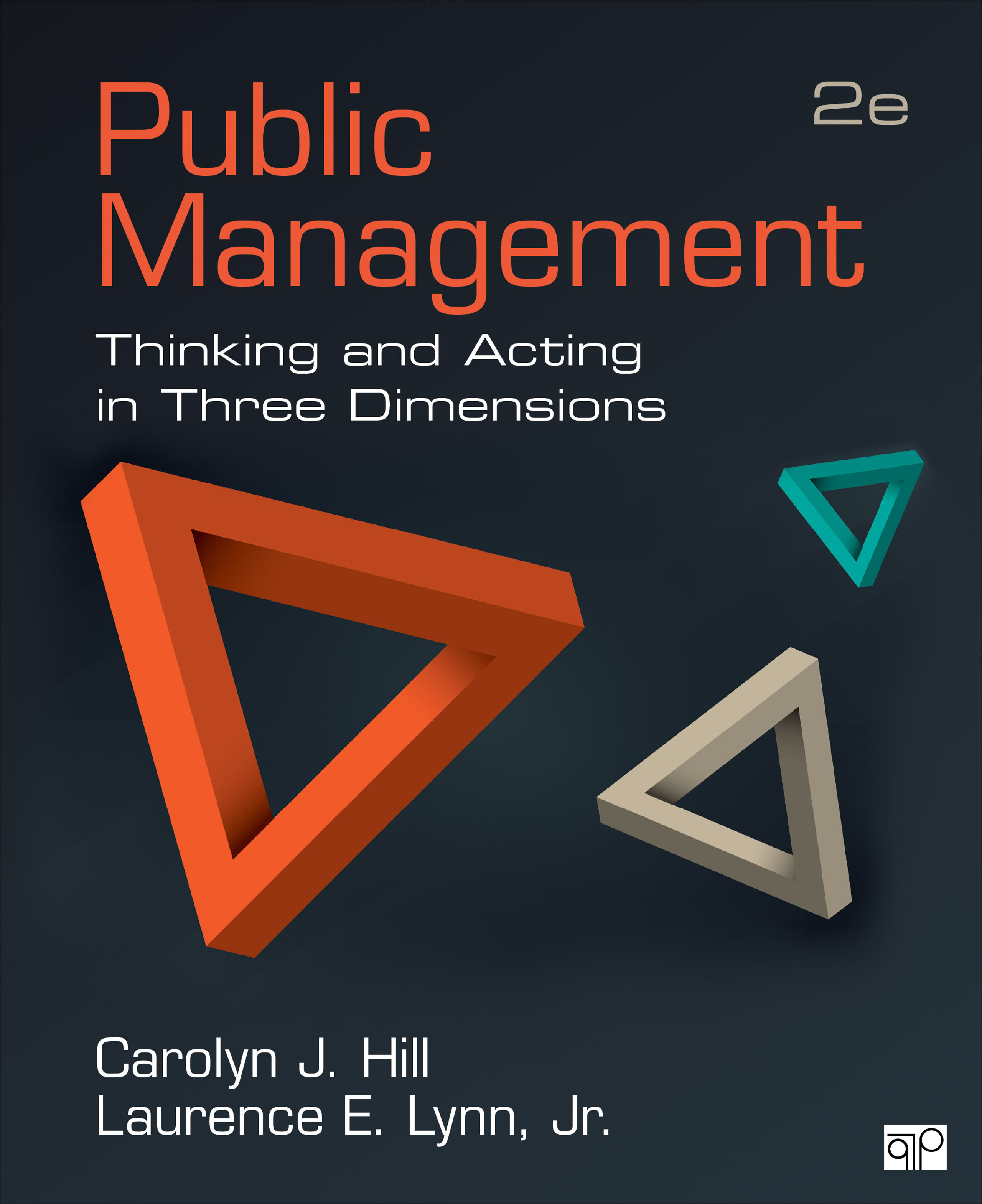
Public Management Managing in the public sector requires an understanding of the interaction between three distinct dimensions—administrative structures, organizational cultures, and the skills of individual managers. Public managers must produce results that citizens and their representatives expect from their government while fulfilling their constitutional responsibilities. In Public Management: Thinking and Acting in Three Dimensions, authors Carolyn J. Hill and Laurence E. Lynn, Jr. argue that one-size-fits-all approaches are inadequate for dealing with the distinctive challenges that public managers face. Drawing on both theory and detailed case studies of actual practice, the authors show how public management that is based on applying a three-dimensional analytic framework—structure, culture, and craft—to specific management problems is the most effective way to improve the performance of America’s unique scheme of governance in accordance with the rule of law. The book educates readers to be informed citizens and prepares students to participate as professionals in the world of public management. POLITICAL SCIENCE,Public Policy,General
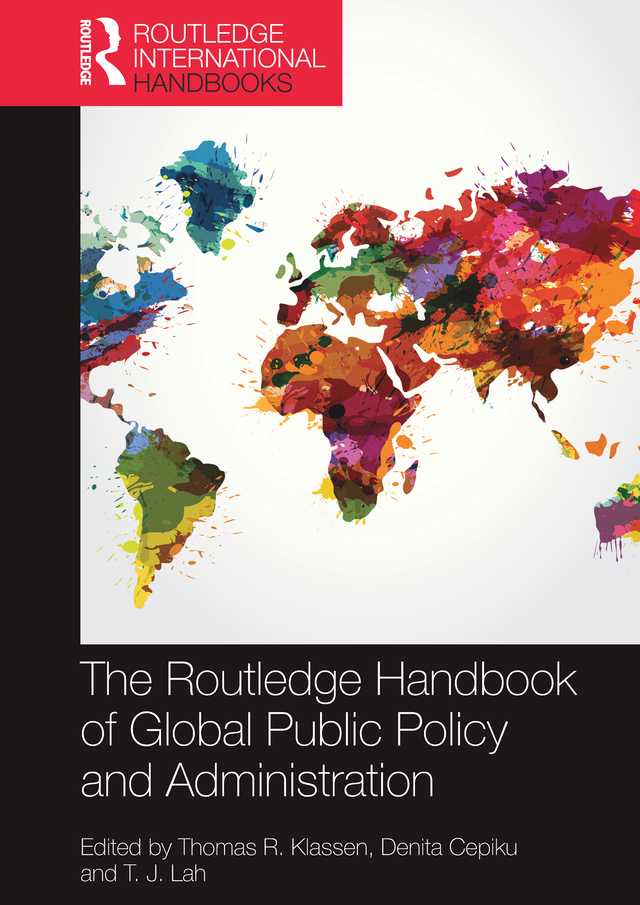
The Routledge Handbook of Global Public Policy and Administration The Routledge Handbook of Global Public Policy and Administration is a comprehensive leading-edge guide for students, scholars and practitioners of public policy and administration. Public policy and administration are key aspects of modern societies that affect the daily lives of all citizens. This handbook examines current trends and reforms in public policy and administration, such as financial regulation, risk management, public health, e-government and many others at the local, national and international levels. The two themes of the book are that public policy and administration have acquired an important global aspect, and that a critical role for government is the regulation of capital. The handbook is organized into three thematic sections – Contemporary Challenges, Policy and Administration Responses and Forging a Resilient Public Administration – to allow readers to quickly access knowledge and improve their understanding of topics. The opening chapter, introductions to sections and extensive glossary aid readers to most effectively learn from the book. Each chapter provides a balanced overview of current knowledge, identifying issues and discussing relevant debates. The book is written by authors from Europe, Asia, North and South America, Africa and Australia. POLITICAL SCIENCE,Public Policy,General

Public Sector Management This exciting seventh edition, now situated in a global context with international examples throughout, has been updated to now cover strategy and planning in the public sector; transparency, accountability and ethics; and non-profit management POLITICAL SCIENCE,Public Policy,General

Enough For more than thirty years, humankind has known how to grow enough food to end chronic hunger worldwide. Yet in Africa, more than 9 million people every year die of hunger, malnutrition, and related diseases every year -- most of them children. In this powerful investigative narrative, Wall Street Journal reporters Kilman & Thurow show exactly how, in the past few decades, Western policies conspired to keep Africa hungry and unable to feed itself. Enough is essential reading on a humanitarian issue of utmost urgency. POLITICAL SCIENCE,Public Policy,General
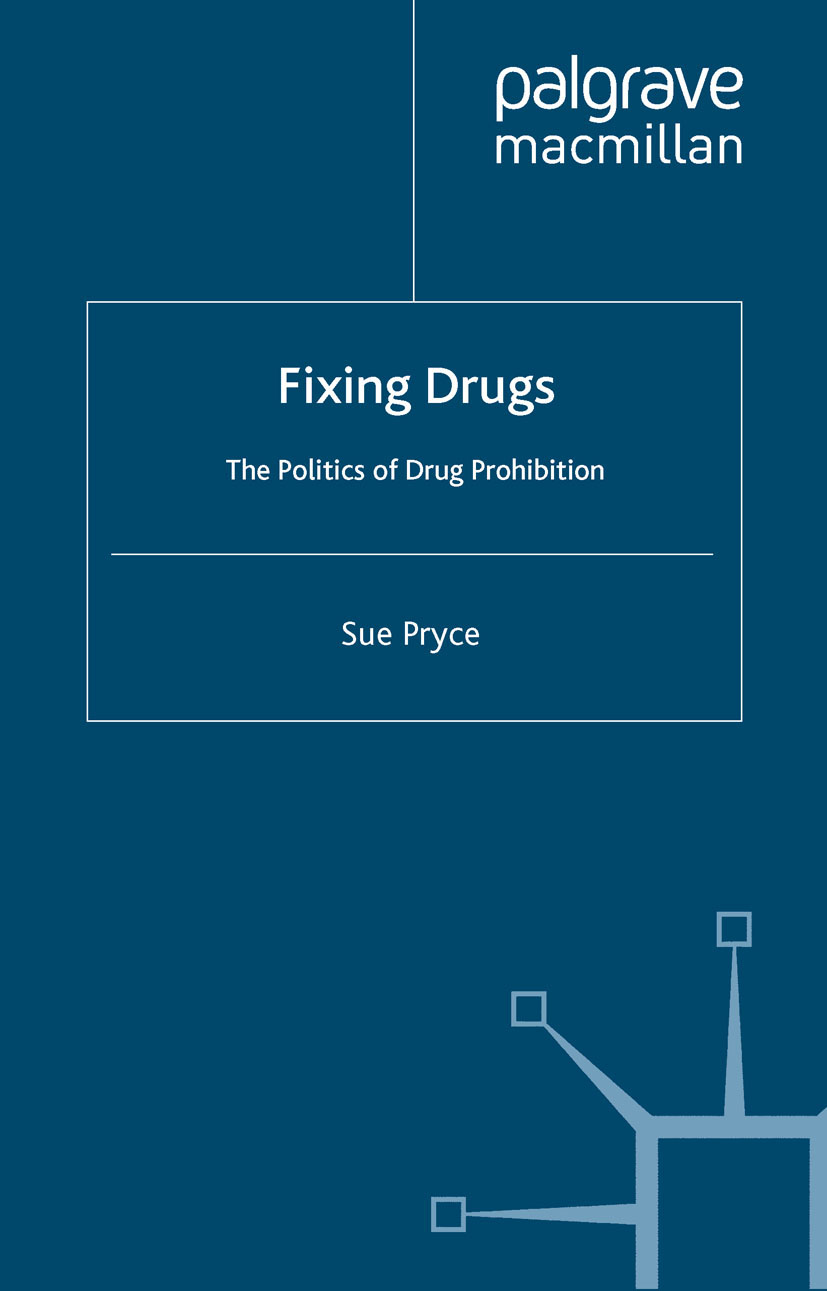
Fixing Drugs In this unique and engaging book, Sue Pryce tackles the major issues surrounding drug policy. Why do governments persist with prohibition policies, despite their proven inefficacy? Why are some drugs criminalized, and some not? And why does society care about drug use at all? Pryce guides us through drug policy around the world. POLITICAL SCIENCE,Public Policy,General

Free Market Environmentalism for the Next Generation This book provides a vision for environmentalism's future, based on the success of environmental entrepreneurs around the world. The work provides the next generation of environmental market ideas and the chapters are co-authored with young scholars and policy analysts who represent the next generation of environmental leaders. POLITICAL SCIENCE,Public Policy,General
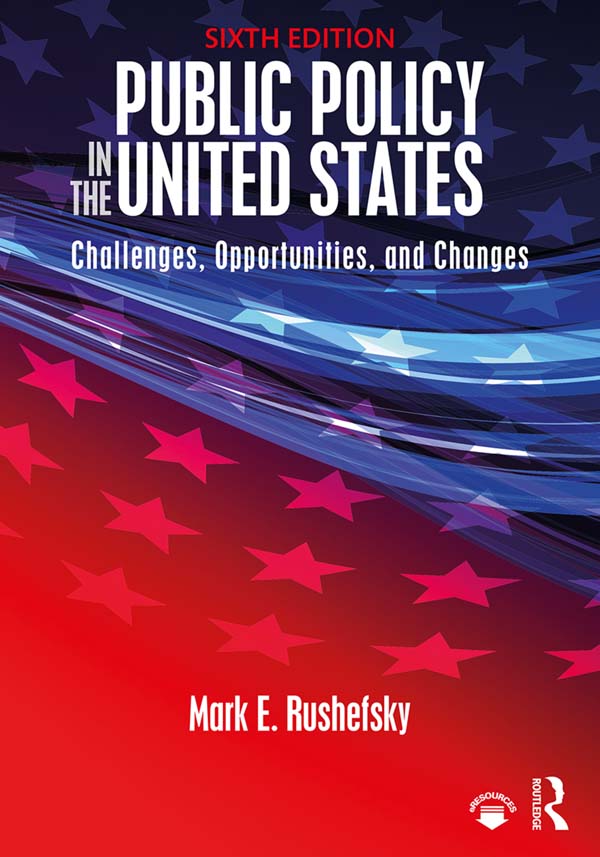
Public Policy in the United States Offering the widest breadth of policy issue coverage on the market, the sixth edition of this well-regarded text covers events through the 2016 elections and beyond. Though the content has been extensively and thoughtfully revised and updated, the sixth edition maintains its clear approach, without an overreliance on policy theory, and popular threefold structure: First, it introduces readers to the American approach to public policy making as it has been shaped by our political institutions, changing circumstances, and ideology. Second, it surveys all of the major policy areas from foreign policy to health care policy to environmental policy, and does so with well-selected illustrations, case studies, terms, and study questions. Third, it provides readers with analytical tools and frameworks to examine current problems and be able to understand and critique proposed public policy solutions. New to the sixth edition is an exploration of: The Affordable Care Act and its implementation, controversies, and impact The American economy since the end of the Great Recession, trade policy, and economic equality issues Foreign policy including relations with Russia, China, and Iran, as well as the civil war in Syria, the continuing conflicts in Iraq, and the challenge of ISIS The US Criminal Justice system and its incarceration challenges as well as issues of minorities, police, and crime. This new edition includes, for the first time, a test bank with multiple choice, short answer, and discussion/essay questions as well as an instructor’s manual. Public Policy in the United States, 6e is an ideal undergraduate text for introductory courses on American Public Policy and Politics, and can be used as supplementary reading in undergraduate courses on policy process, policy analysis, and American government. POLITICAL SCIENCE,Public Policy,General
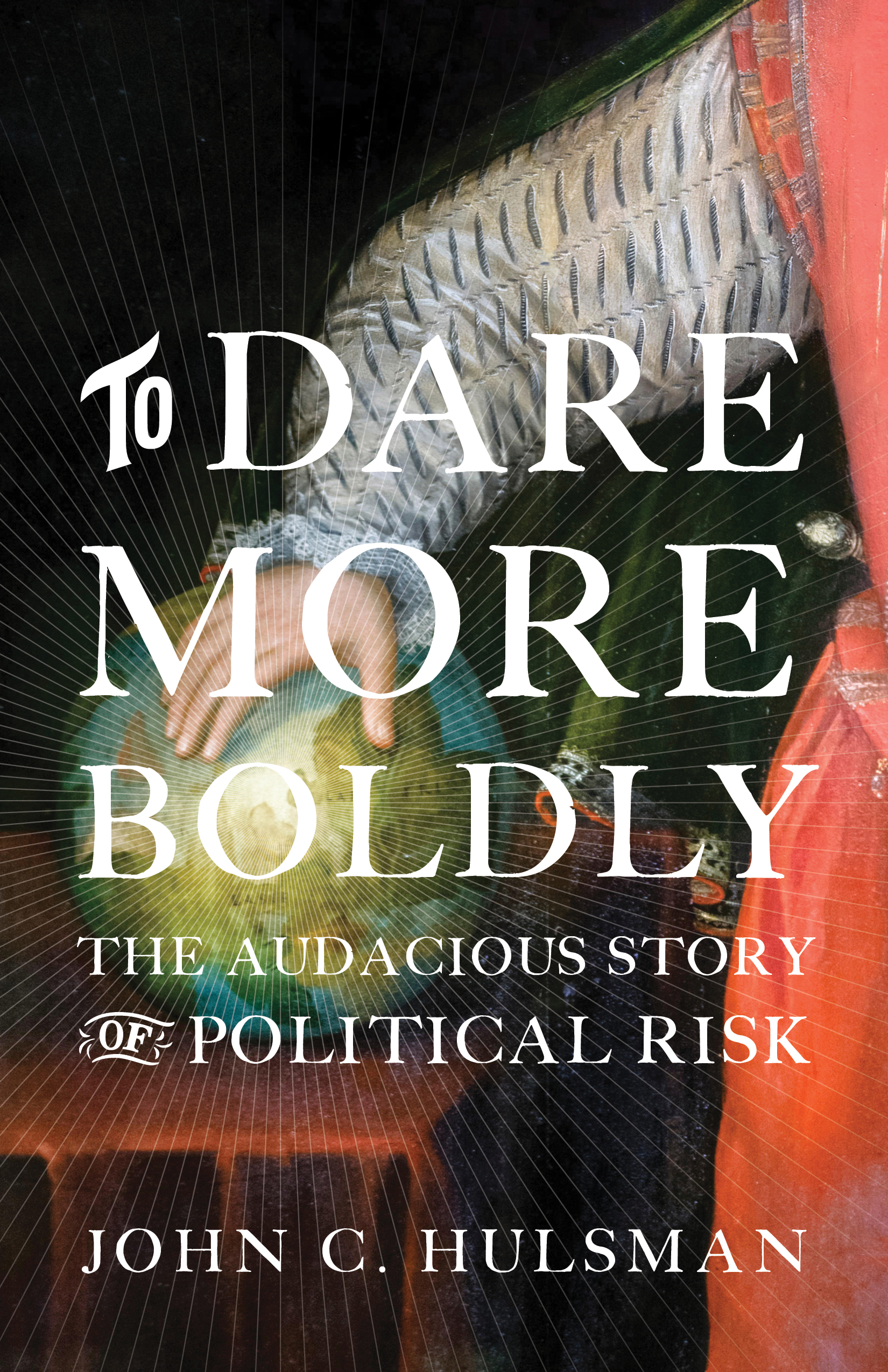
To Dare More Boldly Ten lessons from history on the dos and don’ts of analyzing political risk Our baffling new multipolar world grows ever more complex, desperately calling for new ways of thinking, particularly when it comes to political risk. To Dare More Boldly provides those ways, telling the story of the rise of political risk analysis, both as a discipline and a lucrative high-stakes industry that guides the strategic decisions of corporations and governments around the world. It assesses why recent predictions have gone so wrong and boldly puts forward ten analytical commandments that can stand the test of time. Written by one of the field's leading practitioners, this incisive book derives these indelible rules of the game from a wide-ranging and entertaining survey of world history. John Hulsman looks at examples as seemingly unconnected as the ancient Greeks and Romans, the Third Crusade, the Italian Renaissance, America's founders, Napoleon, the Battle of Gettysburg, the British Empire, the Kaiser's Germany, the breakup of the Beatles, Charles Manson, and Deng Xiaoping's China. Hulsman makes sense of yesterday's world, and in doing so provides an invaluable conceptual tool kit for navigating today's. To Dare More Boldly creatively explains why political risk analysis is vital for business and political leaders alike, and authoritatively establishes the analytical rules of thumb that practitioners need to do it effectively. POLITICAL SCIENCE,Public Policy,General
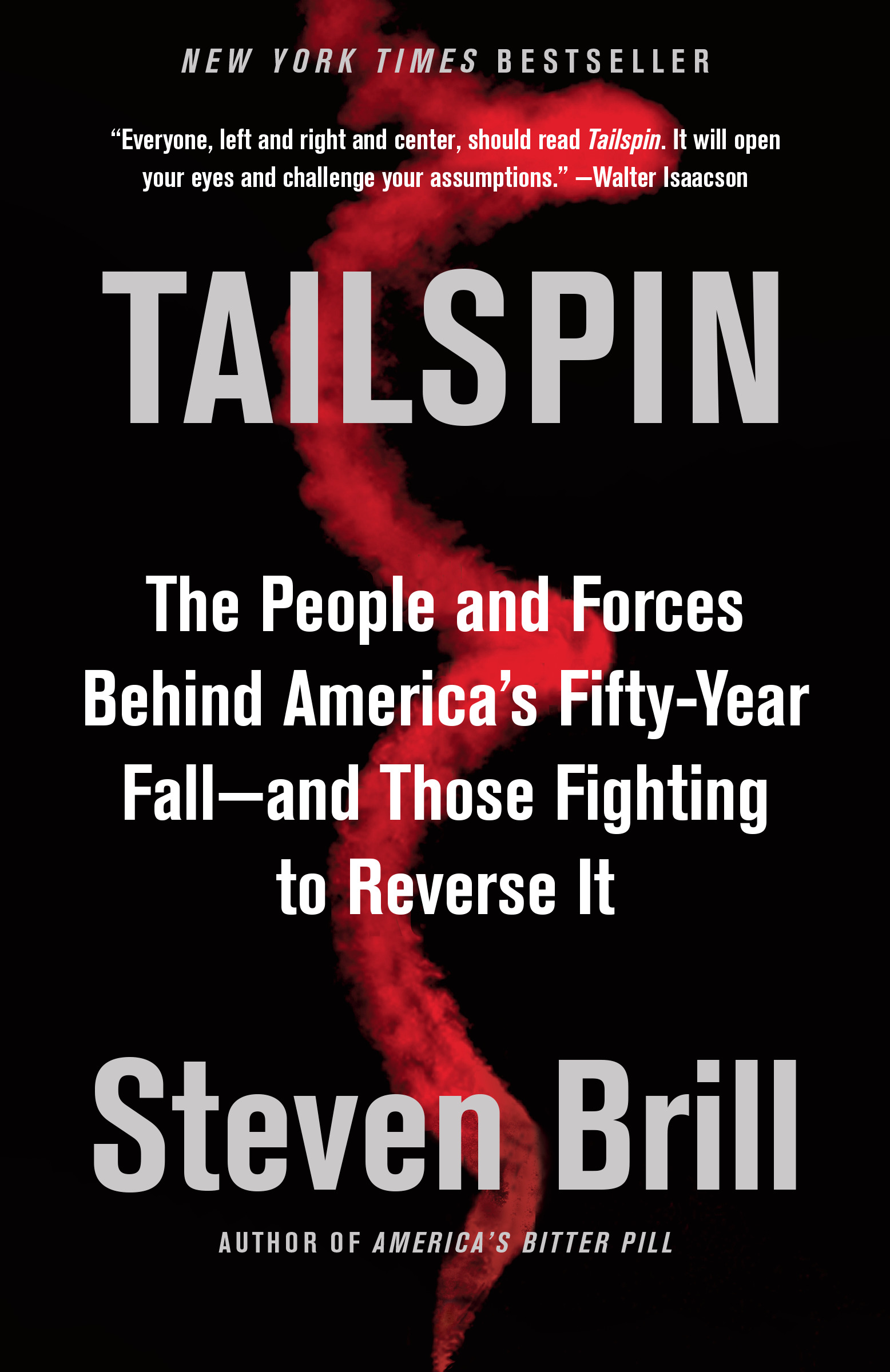
Tailspin In this revelatory narrative covering the years 1967 to 2017, Steven Brill gives us a stunningly cogent picture of the broken system at the heart of our society. He shows us how, over the last half century, America’s core values—meritocracy, innovation, due process, free speech, and even democracy itself—have somehow managed to power its decline into dysfunction. They have isolated our best and brightest, whose positions at the top have never been more secure or more remote. The result has been an erosion of responsibility and accountability, an epidemic of shortsightedness, an increasingly hollow economic and political center, and millions of Americans gripped by apathy and hopelessness. By examining the people and forces behind the rise of big-money lobbying, legal and financial engineering, the demise of private-sector unions, and a hamstrung bureaucracy, Brill answers the question on everyone’s mind: How did we end up this way? Finally, he introduces us to those working quietly and effectively to repair the damages. At once a diagnosis of our national ills, a history of their development, and a prescription for a brighter future, Tailspin is a work of riveting journalism—and a welcome antidote to political despair. POLITICAL SCIENCE,Public Policy,General

Judicial Behavior and Policymaking Judicial Behavior and Policymaking familiarizes students with qualitative and quantitative methods of analyzing data to better understand the field of judicial politics, and how professional political scientists conduct research about the courts. This accessible and engaging text provides a thorough introduction to the world of judicial politics. POLITICAL SCIENCE,Public Policy,General

What's Wrong with Protectionism Lemieux shows how free trade improves the lives of American consumers, especially the poor. The narrow agenda of the protectionists—to protect a small minority of producers at the expense of millions of their fellow Americans—is the wrong path for an increasingly diverse and complex economy. This concise primer shows you why. POLITICAL SCIENCE,Public Policy,General

German Public Policy Since unification German society and institutions have been challenged by various transformations and the need to adjust to changing conditions. While much has been accomplished, many political, legal, and institutional problems remain. This volume deals with selected aspects of domestic and European policy, political parties, the challenge of direct democracy, and federalism in unified Germany – all issues that have been the subject of much discussion, political posturing, legislation, and, to some extent, constitutional amendments and court decision for many years, if not decades. In conclusion, a British scholar looks at German federalism and a number of public policy issues from a comparative perspective and arrives at some surprising and encouraging results. POLITICAL SCIENCE,Public Policy,General

The False Promise of Single-Payer Health Care A government takeover of the US health care system has never looked more plausible. Support for the idea is at an all-time high. Two-thirds of Democratic voters favor “single-payer†health care; even one in four Republicans is on board. In this Broadside, Sally C. Pipes makes the case against single-payer by offering evidence of its devastating effects on patients in Canada, the United Kingdom, and even the United States. Long wait times, substandard care, lack of access to innovative treatments, huge public outlays, and spiraling costs are endemic to single-payer. Those are hardly outcomes we should consider foisting upon the American health care system. POLITICAL SCIENCE,Public Policy,General
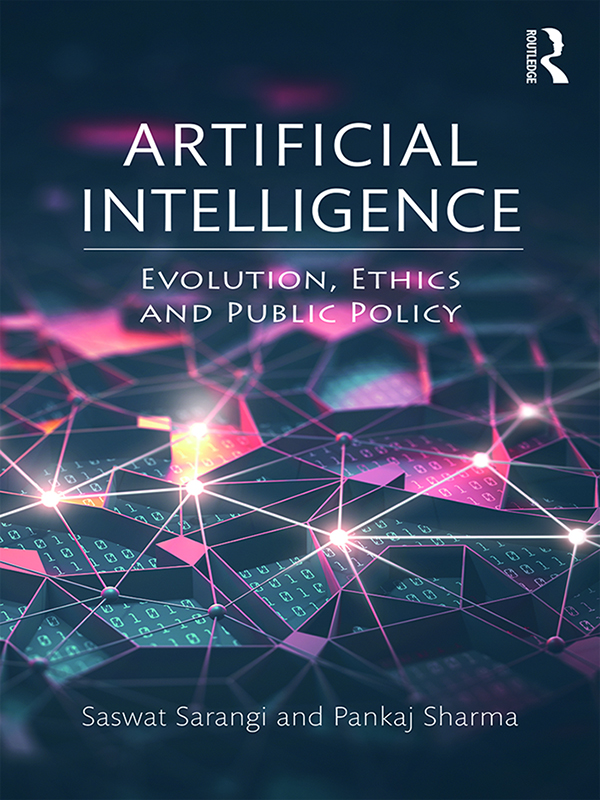
Artificial Intelligence What will the future be? A dystopian landscape controlled by machines or a brave new world full of possibilities? Perhaps the answer lies with Artificial Intelligence (AI)—a phenomenon much beyond technology that has, continues to, and will shape lives in ways we do not understand yet. This book traces the evolution of AI in contemporary history. It analyses how AI is primarily being driven by "capital" as the only "factor of production" and its consequences for the global political economy. It further explores the dystopian prospect of mass unemployment by AI and takes up the ethical aspects of AI and its possible use in undermining natural and fundamental rights. A tract for the times, this volume will be a major intervention in an area that is heavily debated but rarely understood. It will be essential reading for researchers and students of digital humanities, politics, economics, science and technology studies, physics, and computer science. It will also be key reading for policy makers, cyber experts and bureaucrats. POLITICAL SCIENCE,Public Policy,General
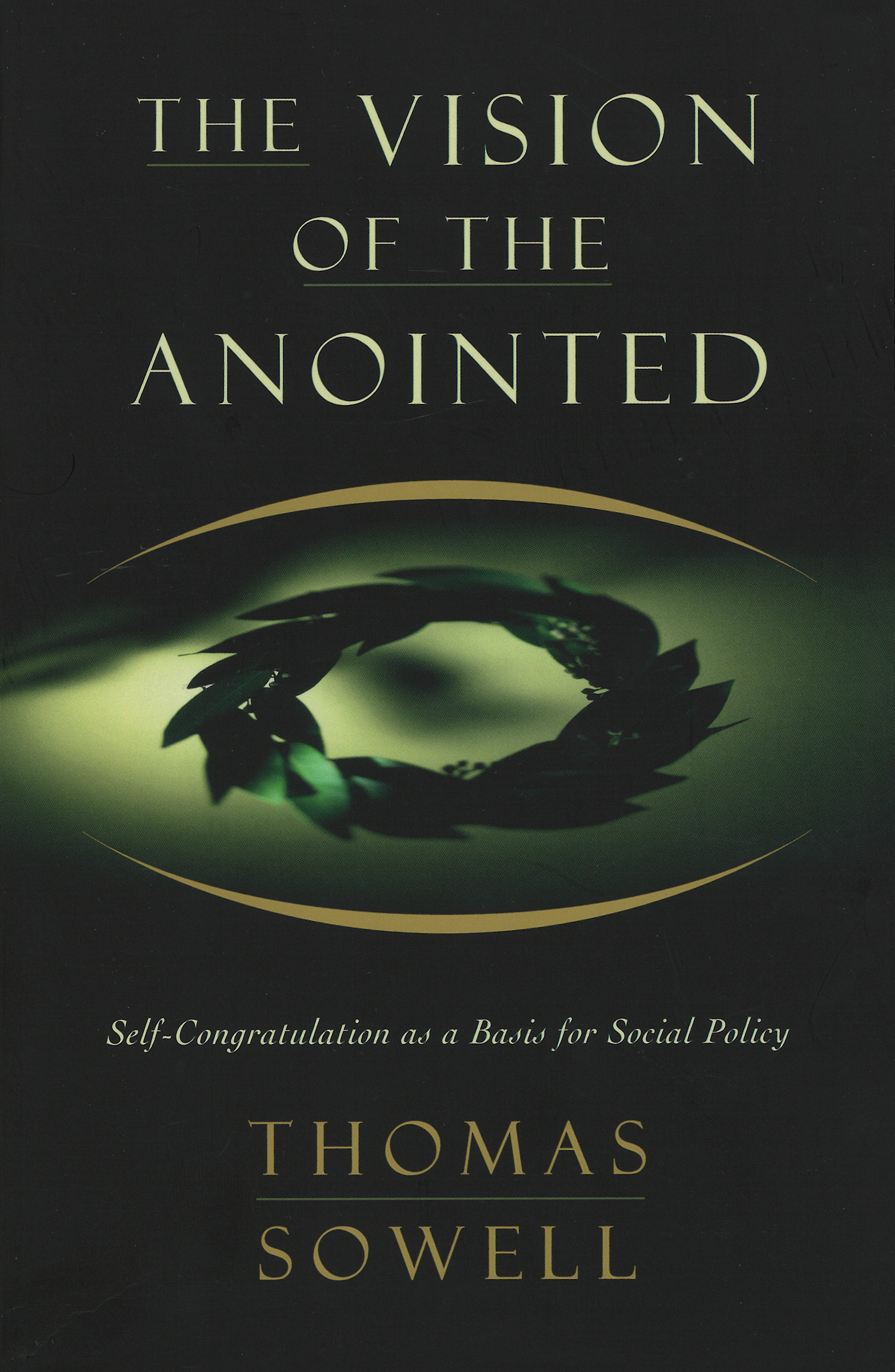
The Vision of the Anointed Sowell presents a devastating critique of the mind-set behind the failed social policies of the past thirty years. Sowell sees what has happened during that time not as a series of isolated mistakes but as a logical consequence of a tainted vision whose defects have led to crises in education, crime, and family dynamics, and to other social pathologies. In this book, he describes how elites—the anointed—have replaced facts and rational thinking with rhetorical assertions, thereby altering the course of our social policy. POLITICAL SCIENCE,Public Policy,General

Healthcare Politics and Policy in America Health policy in the United States has been shaped by the political, socioeconomic, and ideological environment, with important roles played by public and private actors, as well as institutional and individual entities, in designing the contemporary American healthcare system. Now in a fully updated fifth edition, this book gives expanded attention to pressing issues for our policymakers, including the aging American population, physician shortages, gene therapy, specialty drugs, and the opioid crisis. A new chapter has been added on the Trump administration's failed attempts at repealing and replacing the Affordable Care Act and subsequent attempts at undermining it via executive orders. Authors Kant Patel and Mark Rushefsky address the key problems of healthcare cost, access, and quality through analyses of Medicare, Medicaid, the Veterans Health Administration, and other programs, and the ethical and cost implications of advances in healthcare technology. Each chapter concludes with discussion questions and a comprehensive reference list. This textbook will be required reading for courses on health and healthcare policy, as well as all those interested in the ways in which American healthcare has evolved over time. POLITICAL SCIENCE,Public Policy,General

An Introduction to the Policy Process Now in a thoroughly revised Fifth Edition, An Introduction to the Policy Process provides students at all levels with an accessible, readable, and affordable introduction to the field of public policy. In keeping with prior editions, author Tom Birkland conveys the best current thinking on the policy process in a clear, conversational style. Designed to address new developments in both policy theory and policy making, the Fifth Edition includes examinations of: the Brexit referendum result and its effects on the UK, European Union, and world politics, as well as the 2016 election of Donald Trump as President of the United States, and the ways in which these events have caused voters and policy makers to rethink their assumptions; changes to the media environment, including the decline of newspapers and television news, the growth of social media, and the emergence of "fake news"; new policy theory developments like the emergence of the Narrative Policy Framework and continued and newer applications of existing theories of policy process like Advocacy Coalitions, Multiple Streams, Punctuated Equilibrium, and Institutional Analysis and Development; and all-new and updated chapter "at a glance" outlines, definitions of key terms, provocative review questions, recommended reading, visual aids and case studies, theoretical literature, and preentation slides and Test Banks to make teaching from the book easier than ever. Firmly grounded in both social science and political science, An Introduction to the Policy Process provides the most up-to-date and thorough overview of the theory and practice of the policy process, ideal for upper-level undergraduate and introductory graduate courses in Public Policy, Public Administration, and Political Science programs. POLITICAL SCIENCE,Public Policy,General

Comparative Health Policy A broad-ranging introduction to the provision, funding and governance of health care across a variety of systems. This revised fifth edition incorporates additional material on low/middle income countries, as well as broadened coverage relating to healthcare outside of hospitals and the ever-increasing diversity of the healthcare workforce today. POLITICAL SCIENCE,Public Policy,General
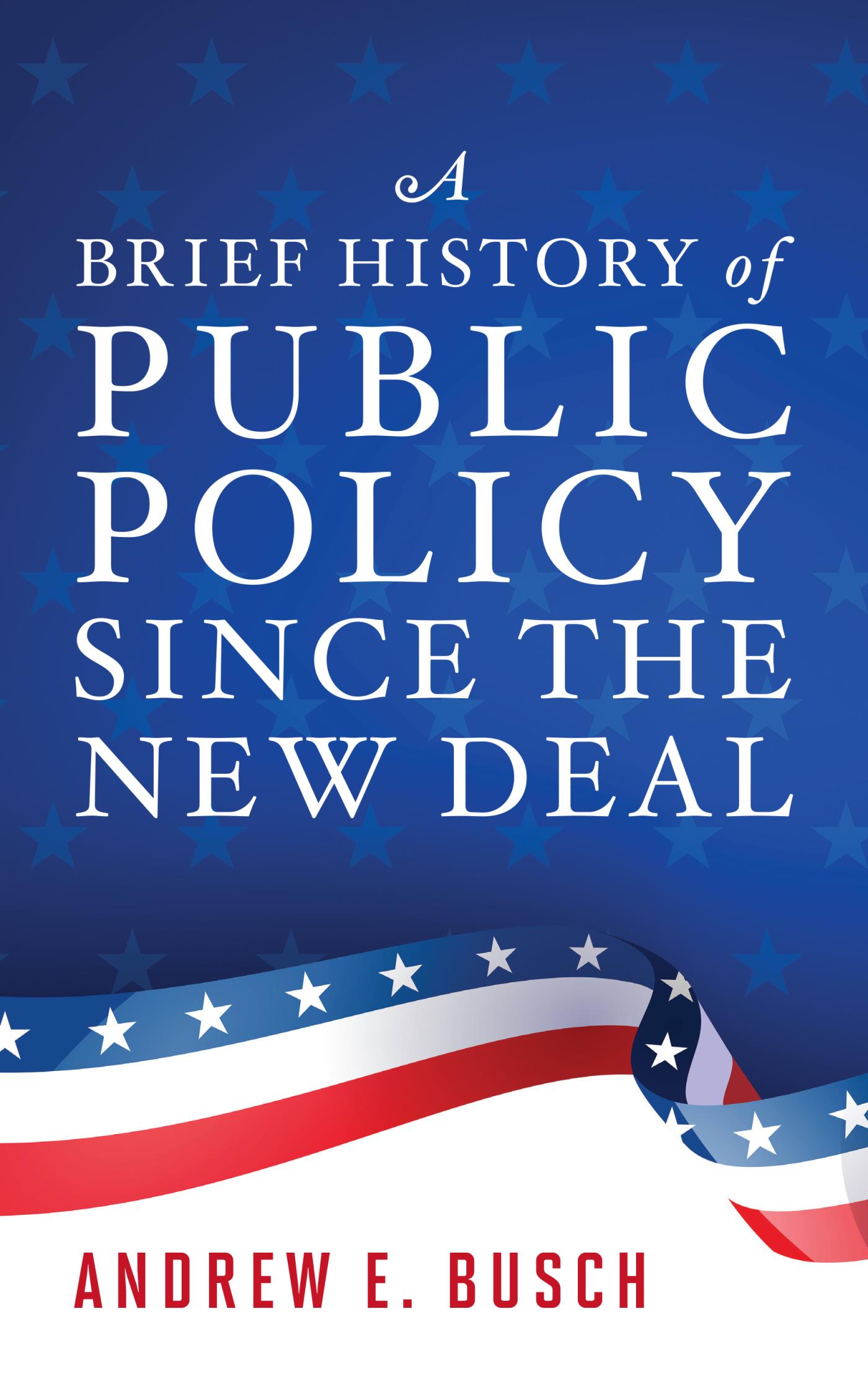
A Brief History of Public Policy since the New Deal This book offers a brief history of domestic public policy since the New Deal. To understand issues such as poverty, immigration, and religious liberty going into the future, it is vital to understand how these issues originated and developed. This is a supplementary text for introduction to public policy courses at the undergraduate level. POLITICAL SCIENCE,Public Policy,General
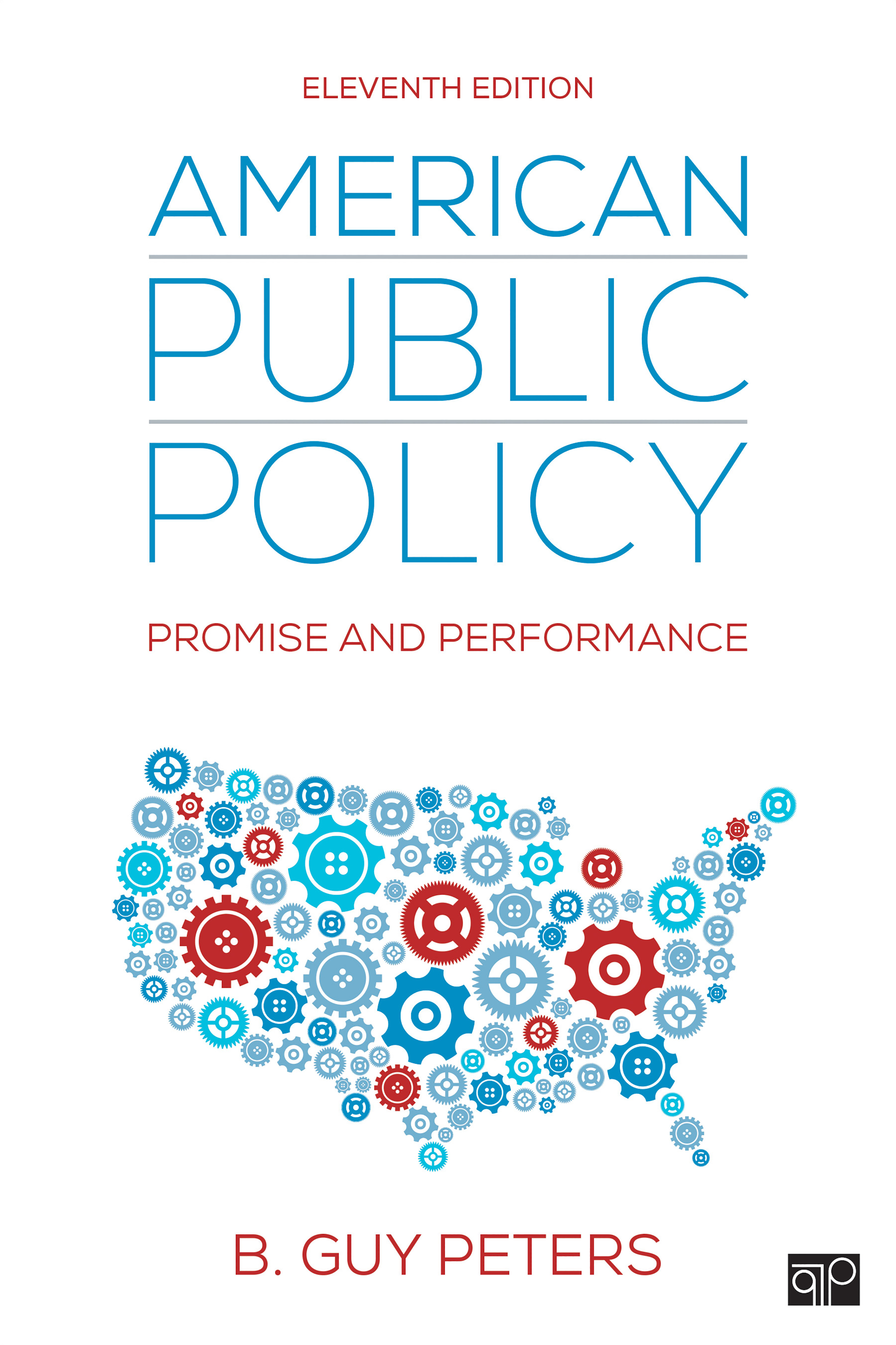
American Public Policy This updated edition of American Public Policy by B. Guy Peters provides a comprehensive yet accessible overview of the policy-making process from procedural approaches and policy instruments to in-depth analysis of specific policy issues. The Eleventh Edition considers how policy has been impacted by recent economic and political developments. Not shying away from the complexity of governmental procedure, Peters ensures that the mechanisms of the policy process are understandable through insightful discussions of topical policy areas. POLITICAL SCIENCE,Public Policy,General
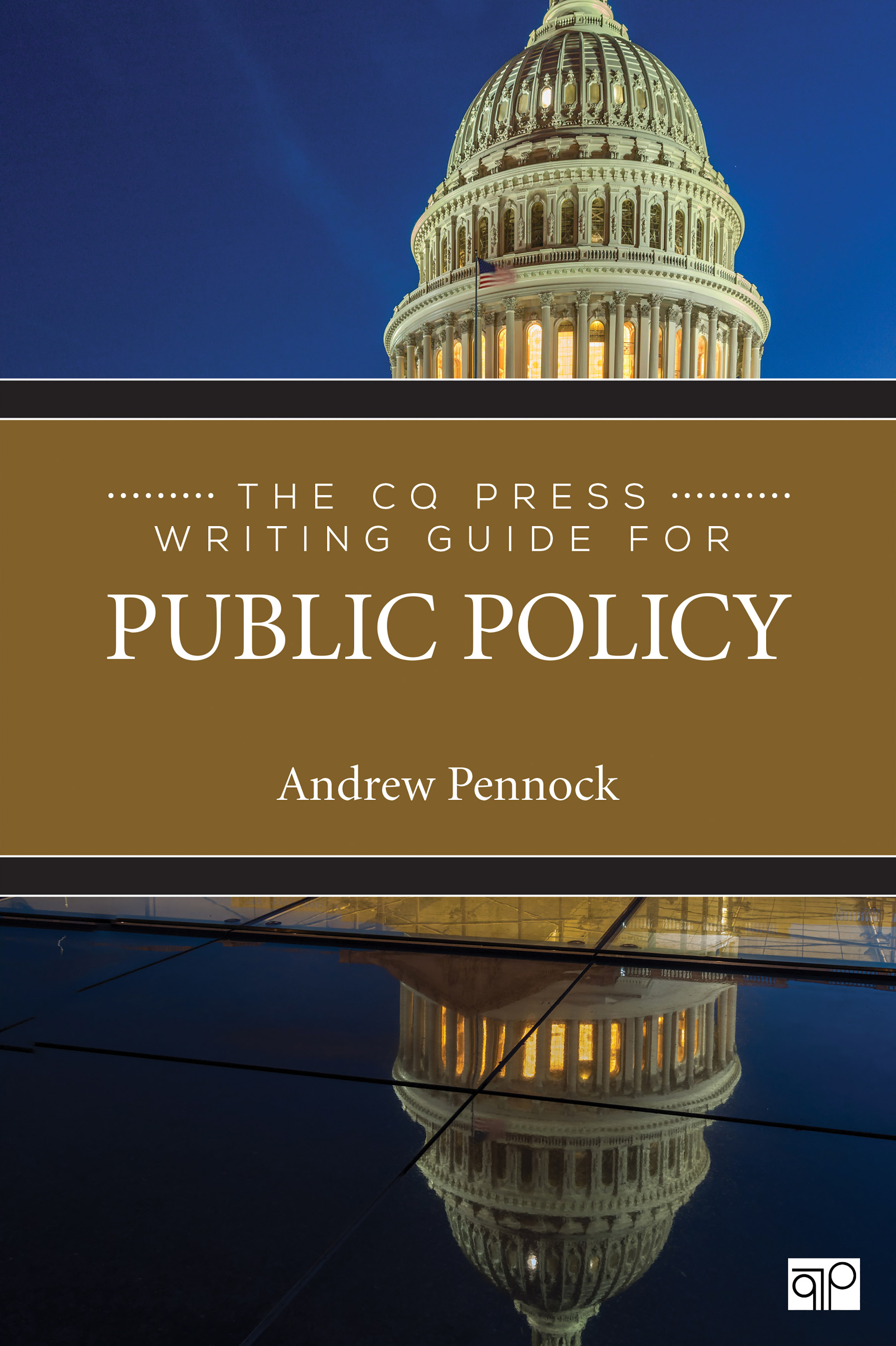
The CQ Press Writing Guide for Public Policy The CQ Press Writing Guide for Public Policy is loaded with rich real world examples that help you master the process of translating insightful policy analysis into clear policy recommendations. Known for his conversational writing style, author Andrew Pennock offers step-by-step instructions on how to write for a variety of genres in a style that policy makers expect. Focusing on an audience-centered approach, you will first learn how to create and organize an argument based on the unique needs and expectations of policy makers. The book then moves onto the nuts and bolts of how to write for a policy audience, with special consideration of ethics and working with visual and technical material. Finally, the book provides practical guidance on writing in specific policy genres: policy memos, briefs, Op-Eds, press releases, written testimony, social media, and emails. Key Features: Basic policy writing tasks help you write sentences, paragraphs and sections that make sense to readers (and to professors!). You will also learn how to create professional quality tables and figures that support your argument as well as how to package these components together effectively to communicate with policy makers. Six separate chapters for various public policy genres (issue briefs, legislative histories, decision memos, testimony, op-eds, and new media) provide you with an overview of the genre, several examples, and an analysis of each example. Current examples from across the field of public policy keep you engaged by connecting the concepts to current topics such as public health (the opioid epidemic, Native-American healthcare, lead poisoning), education (early childhood, school governance), criminal justice (sexting laws, ban-the-box), business regulation (AirBnB, renewable energy, drug pricing), security policy (cyber-security, foreign asset control), and social policy (physician assisted suicide). POLITICAL SCIENCE,Public Policy,General
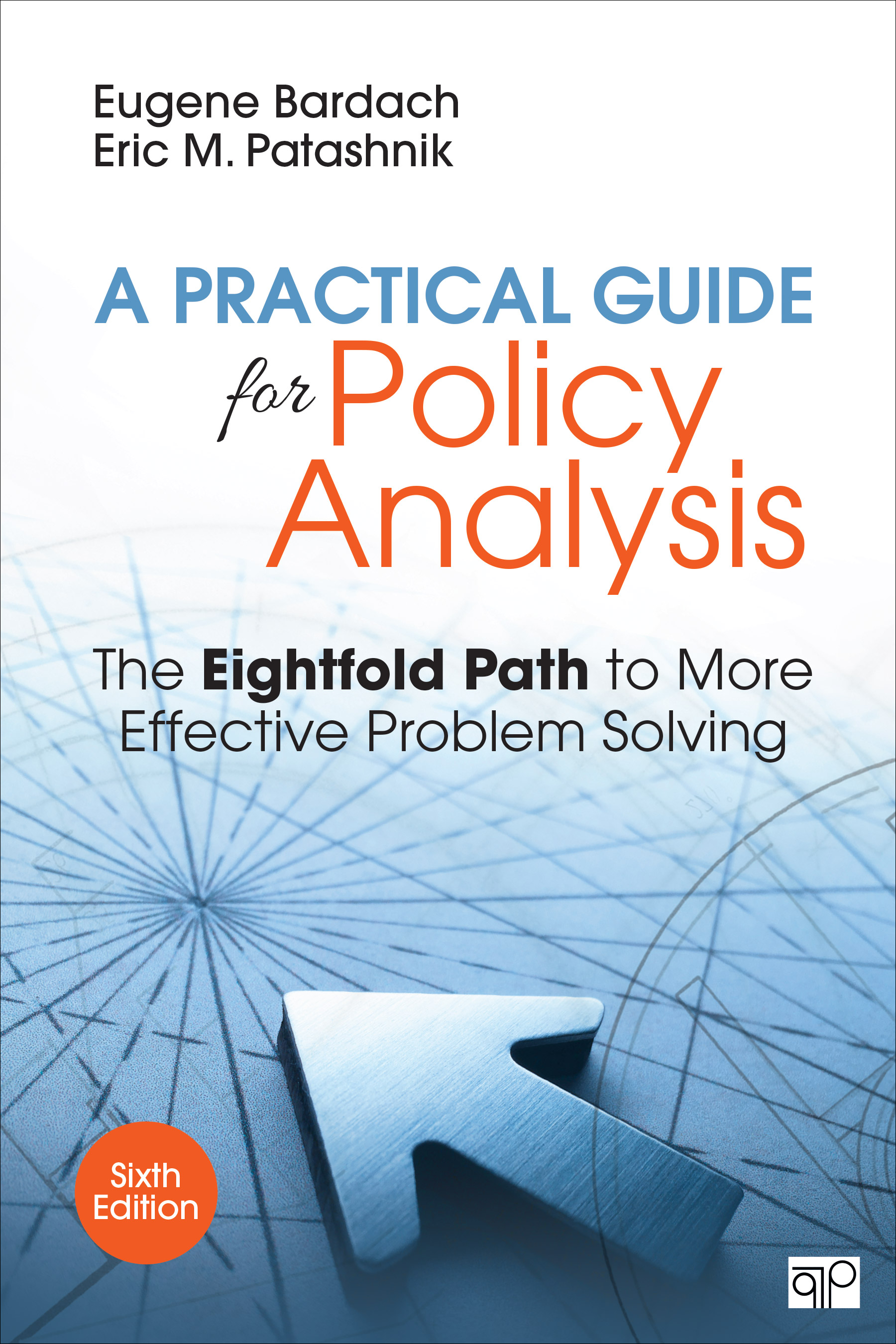
A Practical Guide for Policy Analysis Drawing on more than 40 years of experience with policy analysis, best-selling authors Eugene Bardach and Eric M. Patashnik use real-world examples to teach you how to be effective, accurate, and persuasive policy analysts. The Sixth Edition of A Practical Guide for Policy Analysis presents dozens of concrete tips, new case studies, and step-by-step strategies for the budding analyst as well as the seasoned professional. POLITICAL SCIENCE,Public Policy,General

Public Management and Administration The nature and management of the public sector has changed dramatically since a more flexible, market-based model replaced the rigid, bureaucratic form of public administration of the 20th century. The fourth edition of this highly successful text provides a uniquely broad ranging and international introduction to the field. POLITICAL SCIENCE,Public Policy,General
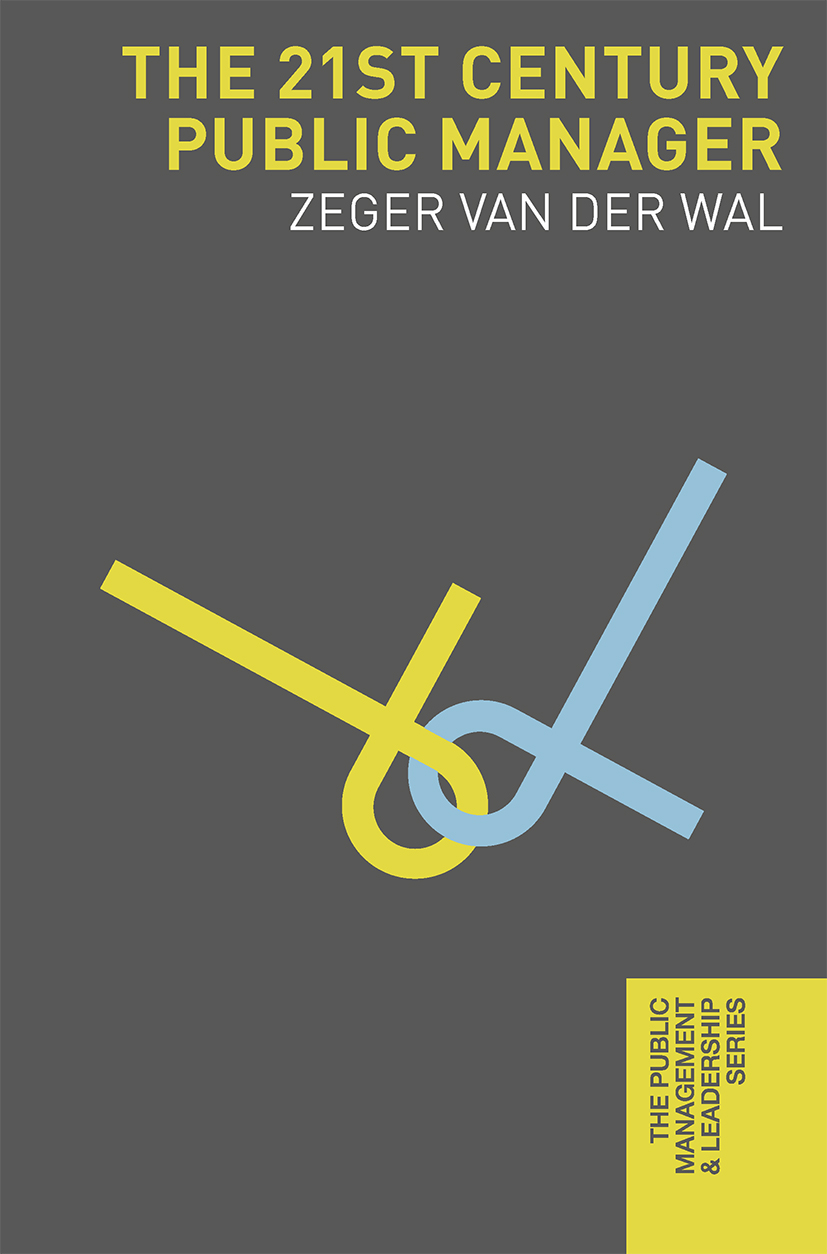
The 21st Century Public Manager Truly global in scope and coverage, this major new introduction to the human side of public management provides an exceptionally broad strategic assessment of human resources issues which will be of interest to all students and practitioners facing the challenges of building administrative capacity in the 21st century. POLITICAL SCIENCE,Public Policy,General

Gun Control In the aftermath of the Port Arthur massacre on 28 April 1996 – when a gunman murdered 35 people and injured another 23 at a popular Tasmanian tourist attraction – John Howard, a conservative prime minister who had been in office for just six weeks, surprised his colleagues and startled the nation by moving swiftly to transform Australia’s lax firearm laws. The National Firearms Agreement, produced just twelve days after the massacre with support from all levels of government and across the political divide, is now held up around the world as a model for gun control.Gun Control analyses whether the Australian Government achieved its intention and what it might have done in response to the massacre, and didn’t. POLITICAL SCIENCE,Public Policy,General
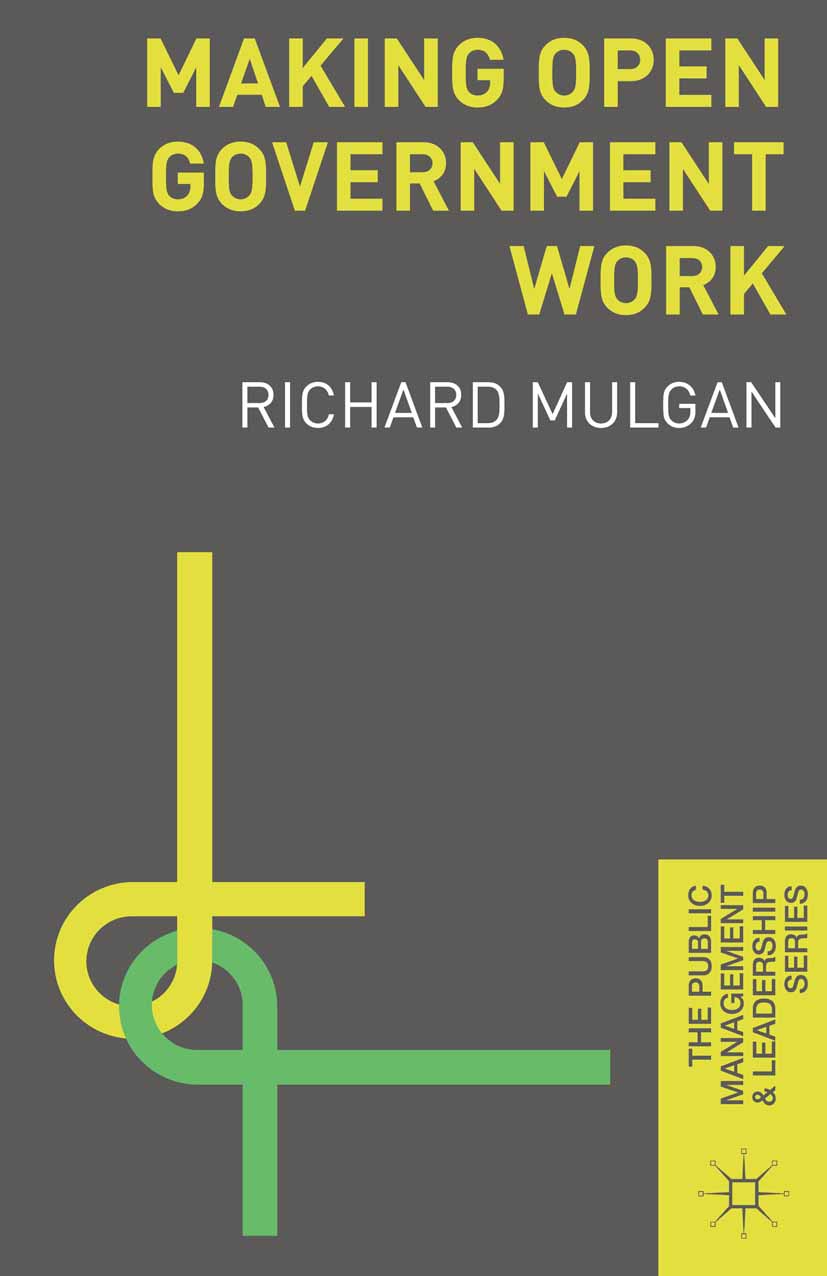
Making Open Government Work A systematic and engaging new text that analyses accountability and transparency in contemporary public services, and examines how open government can be both a challenge and an aid to more effective public management. This text is an ideal guide for both practical and conceptual understanding of the possibilities of open government. POLITICAL SCIENCE,Public Policy,General
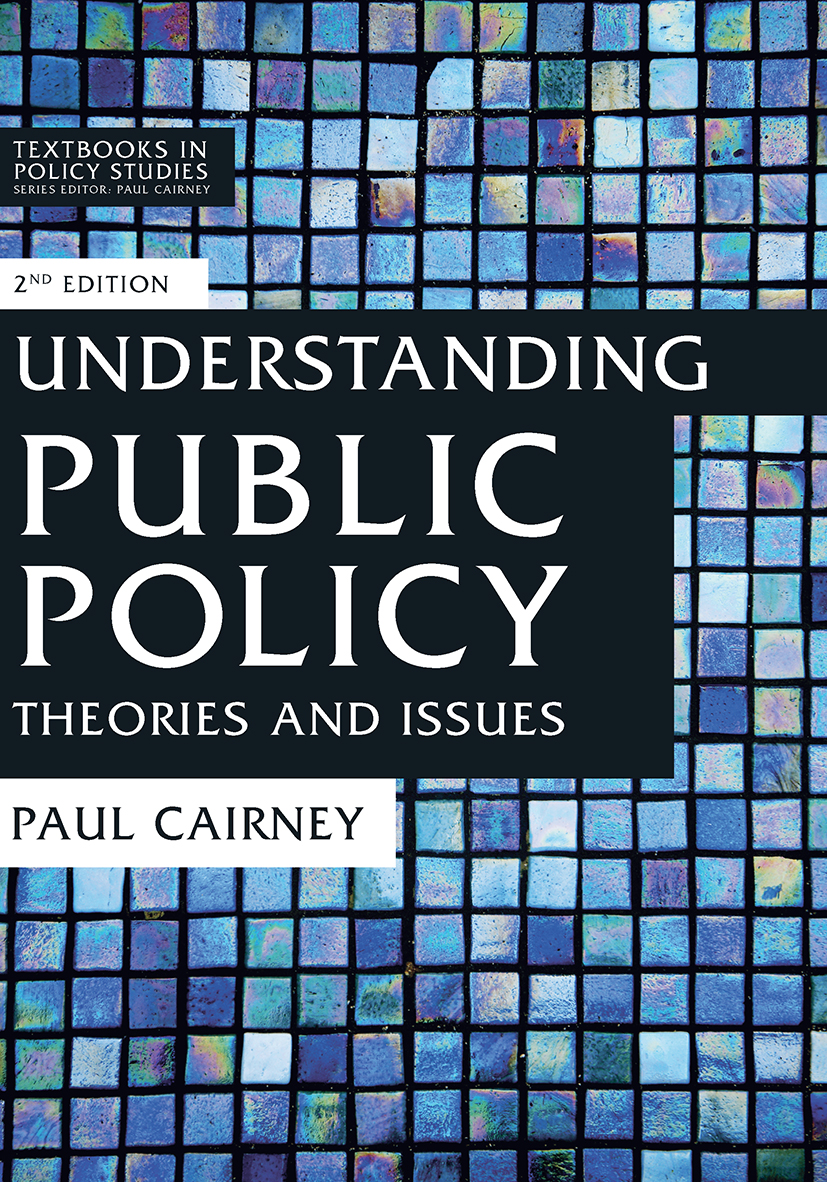
Understanding Public Policy A major new introduction to theories of public policy. The author provides an accessible assessment of a wide range of theories and models from policy cycles, policy transfer, rational choice and socio-economic explanations to multi-level governance, advocacy coalitions and punctuated equilibrium and of their value to policy analysis. POLITICAL SCIENCE,Public Policy,General
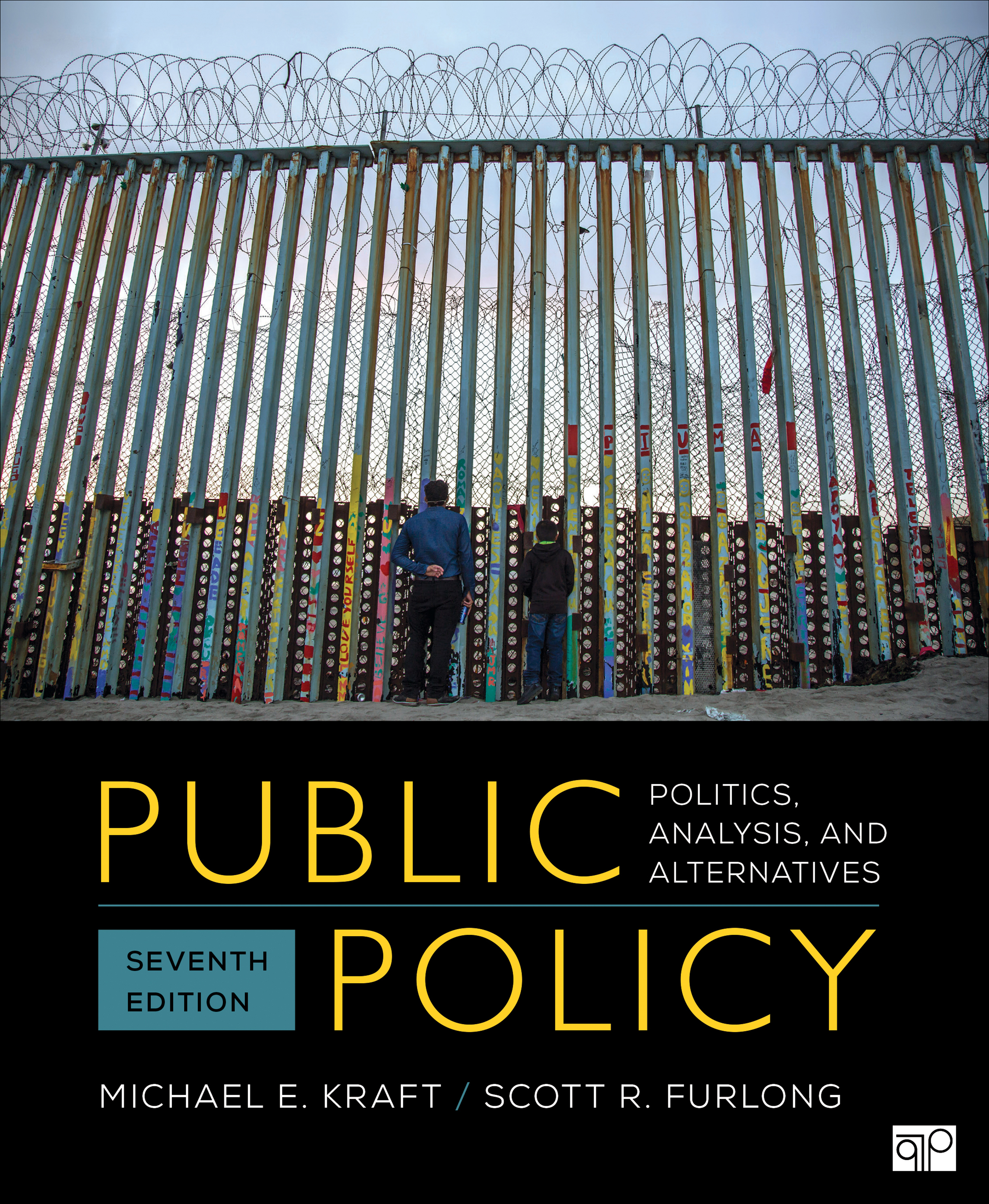
Public Policy With the right information, we can develop public policies that work better. All too often, public policy textbooks offer a basic grounding in the policy process without the benefit of integrating the use of policy analysis. Michael E. Kraft and Scott R. Furlong take a different tack. Public Policy: Politics, Analysis, and Alternatives, Seventh Edition helps students understand how and why policy analysis is used to assess policy alternatives. The text encourages them to not only question the assumptions of policy analyst, but also recognize how these strategies are used in the support of political arguments. The authors introduce and fully integrate an evaluative approach to policy to encourage critical and creative thinking on issues ranging from health care to climate change. From a concise review of institutions, policy actors, and major theoretical models to a discussion of the nature of policy analysis and its practice, Kraft and Furlong show students how to employ evaluative criteria in six substantive policy areas. Students come away with the analytic tools they need to understand that the motivations of policy actors—both within and outside of government—influence a complex yet comprehensible policy agenda. POLITICAL SCIENCE,Public Policy,General
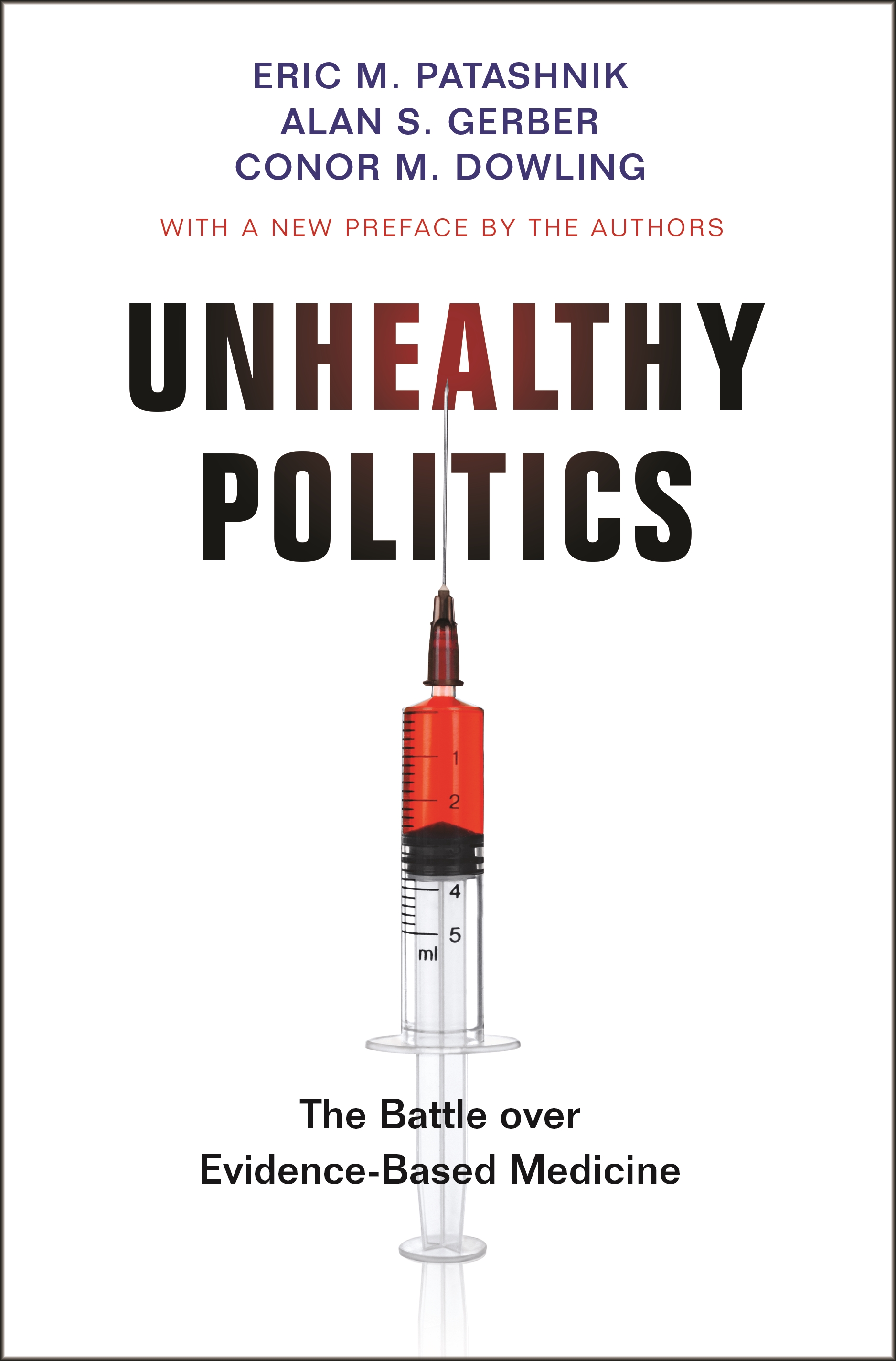
Unhealthy Politics How partisanship, polarization, and medical authority stand in the way of evidence-based medicine The U.S. medical system is touted as the most advanced in the world, yet many common treatments are not based on sound science. Unhealthy Politics sheds new light on why the government's response to this troubling situation has been so inadequate, and why efforts to improve the evidence base of U.S. medicine continue to cause so much political controversy. This critically important book paints a portrait of a medical industry with vast influence over which procedures and treatments get adopted, and a public burdened by the rising costs of health care yet fearful of going against "doctor's orders." Now with a new preface by the authors, Unhealthy Politics offers vital insights into the limits of science, expertise, and professionalism in American politics. POLITICAL SCIENCE,Public Policy,General

Repairing Infrastructures An investigation of the causes and consequences of the strange, ambivalent, and increasingly central role of infrastructure repair in modern life. Infrastructures--communication, food, transportation, energy, and information--are all around us, and their enduring function and influence depend on the constant work of repair. In this book, Christopher Henke and Benjamin Sims explore the causes and consequences of the strange, ambivalent, and increasingly central role of infrastructure repair in modern life. Henke and Sims offer examples, from local to global, to investigate not only the role of repair in maintaining infrastructures themselves but also the social and political orders that are created and sustained through them. POLITICAL SCIENCE,Public Policy,General
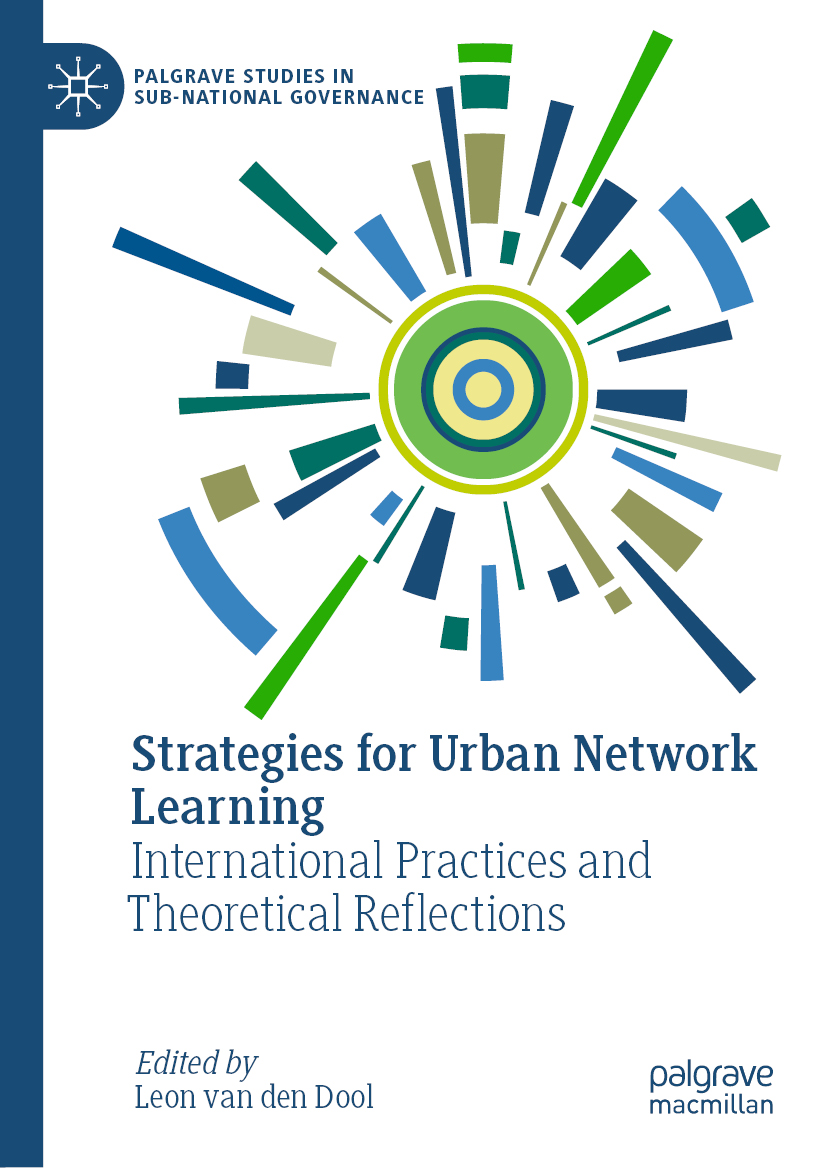
Strategies for Urban Network Learning This book presents international experiences in urban network learning. It is vital for cities to learn as it is necessary to constantly adapt and improve public performance and address complex challenges in a constantly changing environment. It is therefore highly relevant to gain more insight into how cities can learn. Cities address problems and challenges in networks of co-operation between existing and new actors, such as state actors, market players and civil society. This book presents various learning environments and methods for urban network learning, and aims to learn from experiences across the globe. How does learning take place in these urban networks? What factors and situations help or hinder these learning practices? Can we move from intuition to a strategy to improve urban network learning? POLITICAL SCIENCE,Public Policy,General
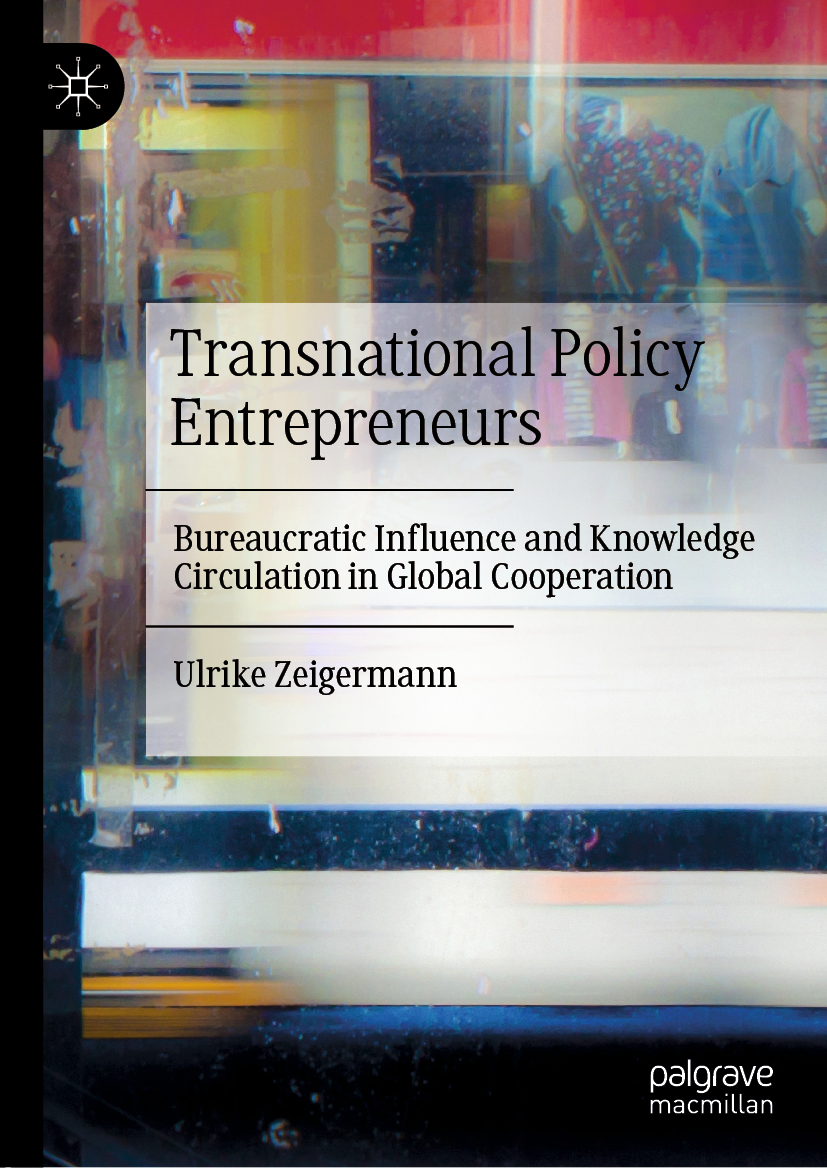
Transnational Policy Entrepreneurs This book explains how transnational policy entrepreneurs have contributed to the transfer of the contested concept of ‘Policy Coherence for Sustainable Development’ (PCSD) in global policy. Tracing the processes by which the PCSD concept has been diffused in an international epistemic community linked to the EU and the OECD, the book offers new insights on international public administrations’ influence on global decision-making. It highlights the dynamic and multi-directional character of knowledge circulation in policy transfer. Drawing on case studies from France, the United Kingdom and Germany, the book contributes to current debates on sustainable development, revealing the role of actors and the logics behind ‘policy coherence’. Thus, it allows to understand the challenges involved in implementing SDG 17. Given its scope, the book will be of considerable interest to academic audiences and students of international relations and policy analysis, as well as practitioners and public officials whose work involves global sustainability policy. POLITICAL SCIENCE,Public Policy,General

New Trends in Public Sector Reporting This book analyses the contribution of the new forms of reporting adopted by Public Sector Organisations in the provision of information on value creation processes to their various stakeholders. The contributors to this volume provide evidence of innovative accounting practices and reporting formats, drawing on case studies from across Europe. Together, they highlight the limitations and opportunities of these new forms of reporting that will require further study and exploration. POLITICAL SCIENCE,Public Policy,General
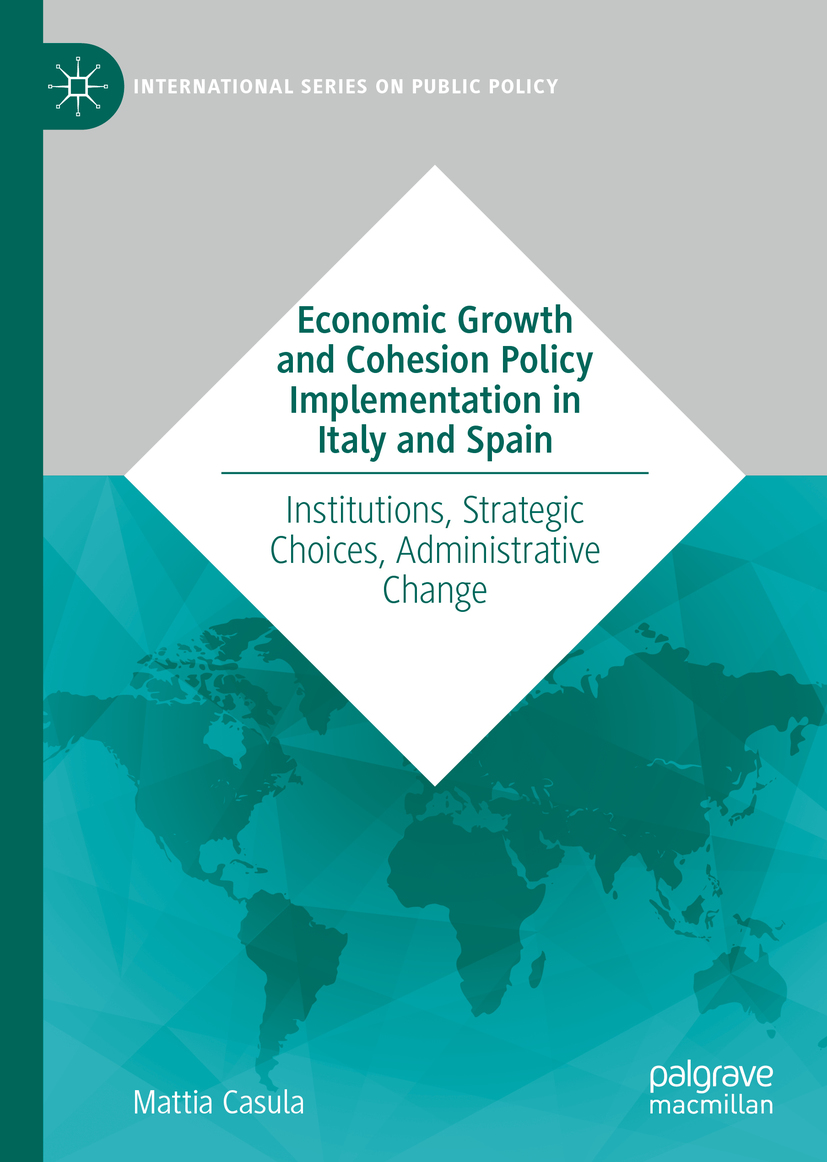
Economic Growth and Cohesion Policy Implementation in Italy and Spain This book concerns EU Cohesion Policy and the economic convergence of underdeveloped regions in Italy and Spain from the first programming period to the present: it investigates the political and institutional factors that determine the success or failure of implementing EU Cohesion Policy at national and sub-national level, as well as their impact on economic growth. On the wave of the American tradition of development studies, this book suggests that public policy analysis can be fruitful for understanding economic growth and cohesion, if it were to reconstruct domestic public interventions for development and the institutional characteristics of the subjects responsible for pursuing development goals. To do so, this book derives its theoretical foundations from the traditional debate on the role of state actors in promoting economic development and on the institutional characteristics that the public authorities involved in the process of economic development should display. More precisely, by adopting an Hirschmanian approach to development, it elaborates an original framework to compare different Cohesion Policy implementations and to understand its economic results in different countries, using Italy and Spain as pilot studies. POLITICAL SCIENCE,Public Policy,General

Environmental Agencies in the United States In Environmental Agencies in the U.S ., the author considers mandates assigned to environmental agencies and how those mandates shape environmental enforcement. Arguing the importance of structure, organizational norms, and state politics, the author crafts a nuanced explanation of the policy differences that shape Americans' well-being. POLITICAL SCIENCE,Public Policy,General

Rivalry And Cooperation In The Asia-pacific Rivalry and Cooperation in the Asia-Pacific provides a comprehensive and accessible introduction to the most important strategic and economic region in the world. Asia-Pacific is a region that is undergoing a major transformation, largely as a consequence of the rise of China and its growing rivalry with the United States. Whatever happens in the Asia-Pacific will profoundly influence global events, not just regional ones. Looking ahead, the region's future direction — and even its name — is contested and uncertain.This two-volume reference work, by one of the world's leading analysts of regional affairs, places these events in historical context and considers what they may mean for future political, economic and strategic relations. By focusing on the United States, China and the region's most significant middle powers, the book explains why and how the Asia-Pacific has become the fulcrum of international events. POLITICAL SCIENCE,Public Policy,General

The New New Zealand In this timely book, New Zealand's best-known commentator on population trends, Distinguished Professor Paul Spoonley, shows how, as New Zealand moves into the 2020s, the demographic dividends of the last 70 years are turning into deficits. Our population patterns have been disrupted. More boomers, fewer children, an ever bigger Auckland and declining regions are the new normal. We will need new economic models, new ways of living. Spoonley says: ‘It is not a crisis (even if at times it feels like it), but rather something that needs to be understood and responded to. But I fear that policy-makers and politicians are not up to the challenge. That would be a crisis.' POLITICAL SCIENCE,Public Policy,General
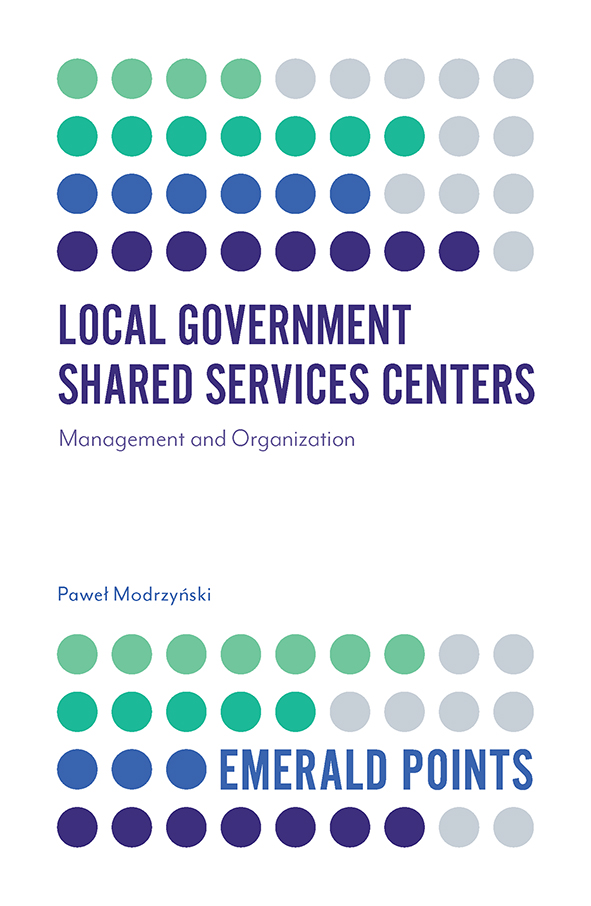
Local Government Shared Services Centers Built on independent research and financial audits of a number of newly created Shared Service Centers (SSCs) in Poland, Local Government Shared Services Centers: Management and Organization is the first book to thoroughly examine the organization, development and effectiveness of the shared service market in the Polish public sector. POLITICAL SCIENCE,Public Policy,General

Politics And Governance In Indian States Understanding India's politics and governance requires an examination of how politics and governance occur in the regional States, which constitute the federal units of India.This book addresses the issues of federalism, power-sharing and constitutional reforms, and their effects on governance in Indian States. Located within the growing literature on new State politics in India, this volume presents a critical, in-depth analysis of politics in Bihar, West Bengal and Tripura — these States being units of analysis for more general implications.What common obstacles have impeded development in each State, and what factors have favored recent, rapid development in some States but not others? The issues of caste conflicts, ethnic conflicts and other collective identity issues will be examined in this book — a pioneer volume with detailed, empirically-based research on the implications of State-centric politics in India. POLITICAL SCIENCE,Public Policy,General

Regulating Telecommunications in South Africa This book provides the first full account of the 20-year story of universal access and service in South Africa’s ICT sector. From 1994 the country’s first democratic government set out to redress the deep digital divide afflicting the overwhelming majority of its citizens, already poor and disenfranchised, but likewise marginalised in access to telephone infrastructure and services. By this time, an incipient global policy regime was driving reforms in the telecomms sector, and also developing good practice models for universal service. Policy diffusion thus led South Africa to adopt, adapt and implement a slew of these interventions. In particular, roll-out obligations were imposed on licensees, and a universal service fund was established. But an agency with a universal service mandate was also created; and licences in under-serviced areas were awarded. The book goes on to identify and analyse the policy success and failure of each of these interventions, and suggests some lessons to be learned. POLITICAL SCIENCE,Public Policy,General

Single Payer Healthcare Reform The recent rise of “Medicare for All†in American political discourse was many years in the making. Behind this rise is a movement composed of grassroots activists and organizations that have been working for more than three decades to achieve the goal of establishing a single-payer healthcare system in the United States. In the past decade, the Single Payer Movement has grown and garnered more public and political support than ever before. This relative success cannot be attributed to any one political figure or political era. The story of how this happened, and how it is tied to a turn against establishment politics on both the left and right, as well as the rise of outsider politicians such as Senator Bernie Sanders, takes place during the Clinton, G.W. Bush, Obama, and Trump administrations. During each of these eras, activists experienced shifting opportunities that they interpreted through the telling of stories. These narratives of opportunity encouraged participation in particular forms of grassroots mobilization, which then affected the outcome of each era. This has had lasting effects on the development of healthcare policy in the United States. In this book, Hern conducts a political ethnographic analysis in which she uses historical records, interviews, and participant observation to tell the story of the Single Payer Movement, establish the lessons that can be learned from this history, and develop a framework—the Environment of Opportunity Model—that involves a holistic understanding of social movement activity through the analysis of narrative practice. POLITICAL SCIENCE,Public Policy,General

The Resurgence of Parish Council Powers in England Parish councils are often underappreciated and undervalued in what they do even though they are an essential part of the governing of England today. In spite of this, the number of parish councils and the roles they perform are increasing. This book explores the reasons for this apparent resurgence in parish councils. Some of it is a response to local demand, especially with the impact of austerity on local government as a whole. At the same time, austerity measures have seen moves to much larger units of local government. Again, the demand for a more local tier of government has resulted in the creation of new parish councils. There is a huge caveat and this is in relation to capacity. Do these new councils have the capacity to deliver the services demanded of them? POLITICAL SCIENCE,Public Policy,General
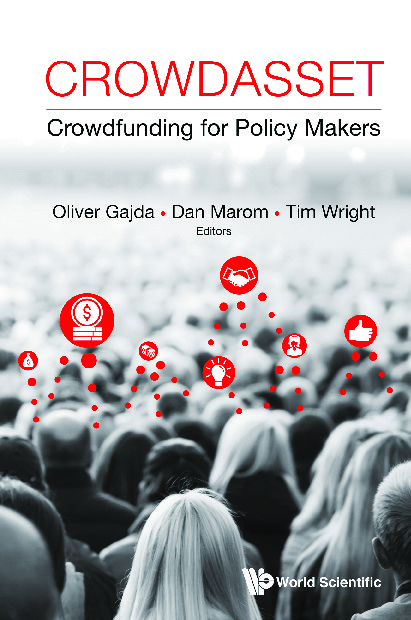
Crowdasset Crowdfunding is already transforming the way many entrepreneurs and enterprises around the globe think about community engagement and fundraising for various causes. This book puts forth the belief that policymakers, public servants and various governments, municipalities and regions can significantly benefit from crowdfunding through employing crowd-related mechanisms within their frameworks and using their crowd as an asset — a crowdasset. Using real-world examples, this book explores the opportunities presented by crowdfunding and crowdfunded innovation, and how major policymakers are already using crowdfunding and crowd mechanisms to accelerate innovation, engagement and community transformation. A guide for those involved in crowdfunding, CrowdAsset brings readers through the journey of maximising crowd impact. POLITICAL SCIENCE,Public Policy,General
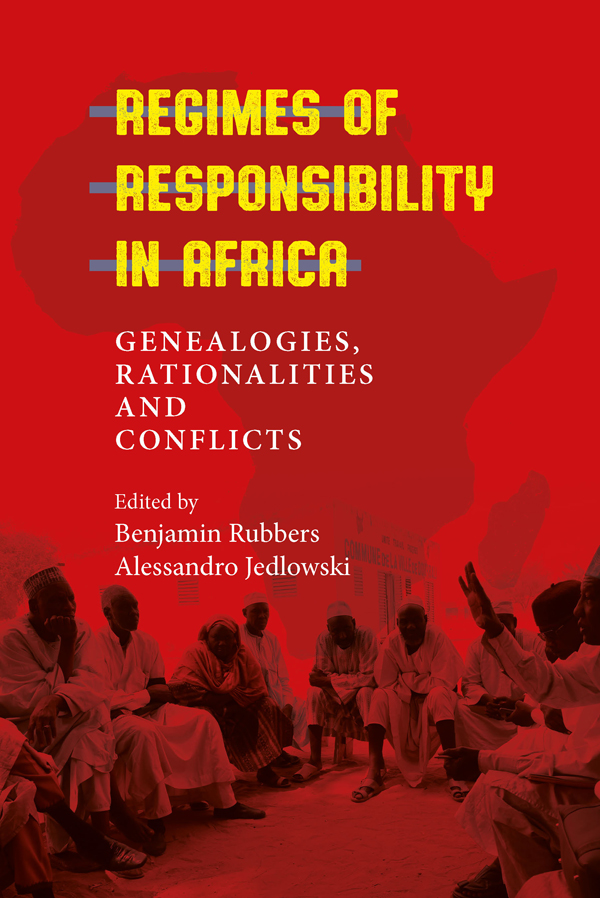
Regimes of Responsibility in Africa Regimes of Responsibility in Africa Âanalyses the transformations that discourses and practices of responsibility have undergone in Africa. By doing so, this collection develops a stronger grasp of the specific political, economic and social transformations taking place today in Africa. At the same time, while focusing on case studies from the African continent, the work enters into a dialogue with the emerging corpus of studies in the field of ethics, adding to it a set of analytical perspectives that can help further enlarge its theoretical and geographical scope. POLITICAL SCIENCE,Public Policy,General
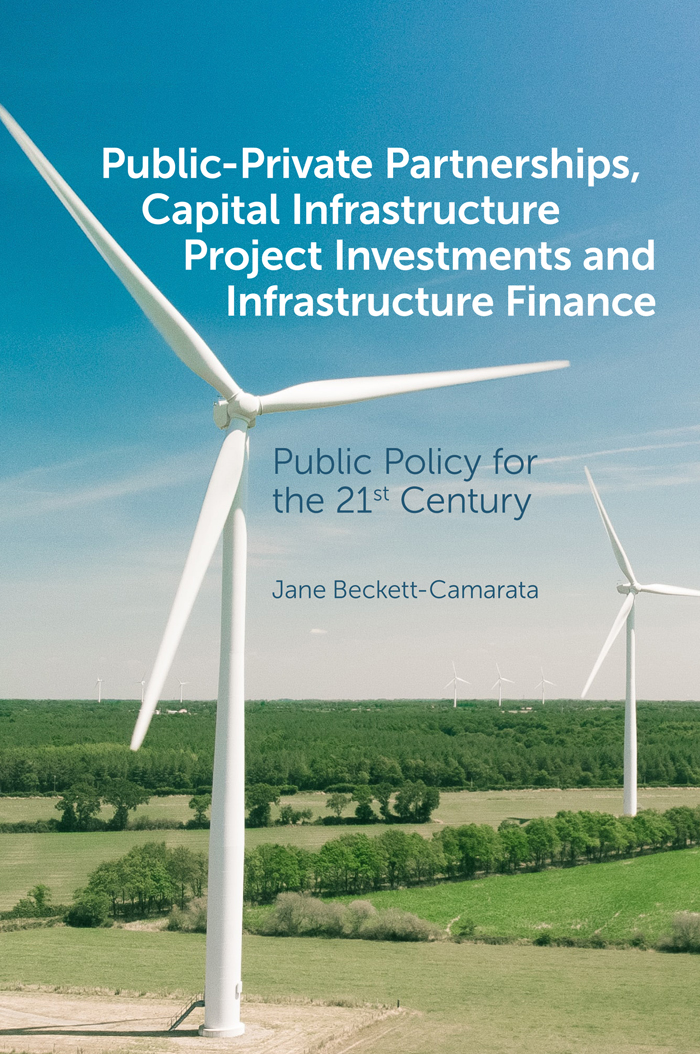
Public-Private Partnerships, Capital Infrastructure Project Investments and Infrastructure Finance Through the introduction of a new lens through which to view infrastructure finance policy, this book analyses the role of Public Private Partnerships within the context of long-term capital investment and improvement planning, and as a critical aspect of effective long-term capital infrastructure finance policy. POLITICAL SCIENCE,Public Policy,General
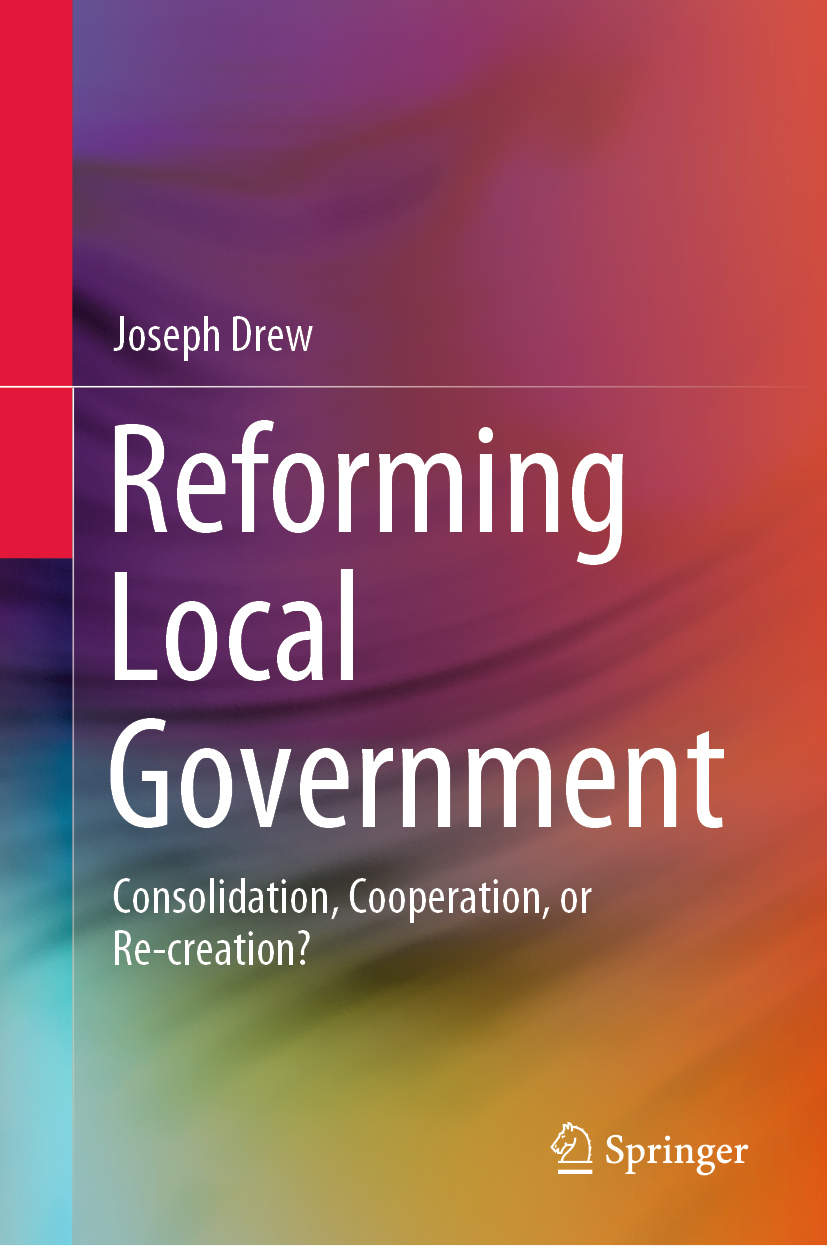
Reforming Local Government This book is a bold prescription for local government reform that moves well beyond the old arguments regarding consolidations (also referred to as amalgamations) and co-operation (sometimes referred to as shared services) to paint a picture of an efficient, effective tier of government that strikes a balance between the right of persons to pursue their existential ends and the need to promote the common good. The book presents a system of local government that balances human dignity with the common good, restrains Leviathan, provides a voice for the disenfranchised (and even the disinterested), and delivers goods and services efficiently and effectively. Ironically, what is often argued to be the weakness of local government in many jurisdictions – the fact that it is merely a creature of statute – is also the best hope we have of making the oft cited rhetoric about how ‘local government is the closest to the people that serves the people best’ become reality. POLITICAL SCIENCE,Public Policy,General
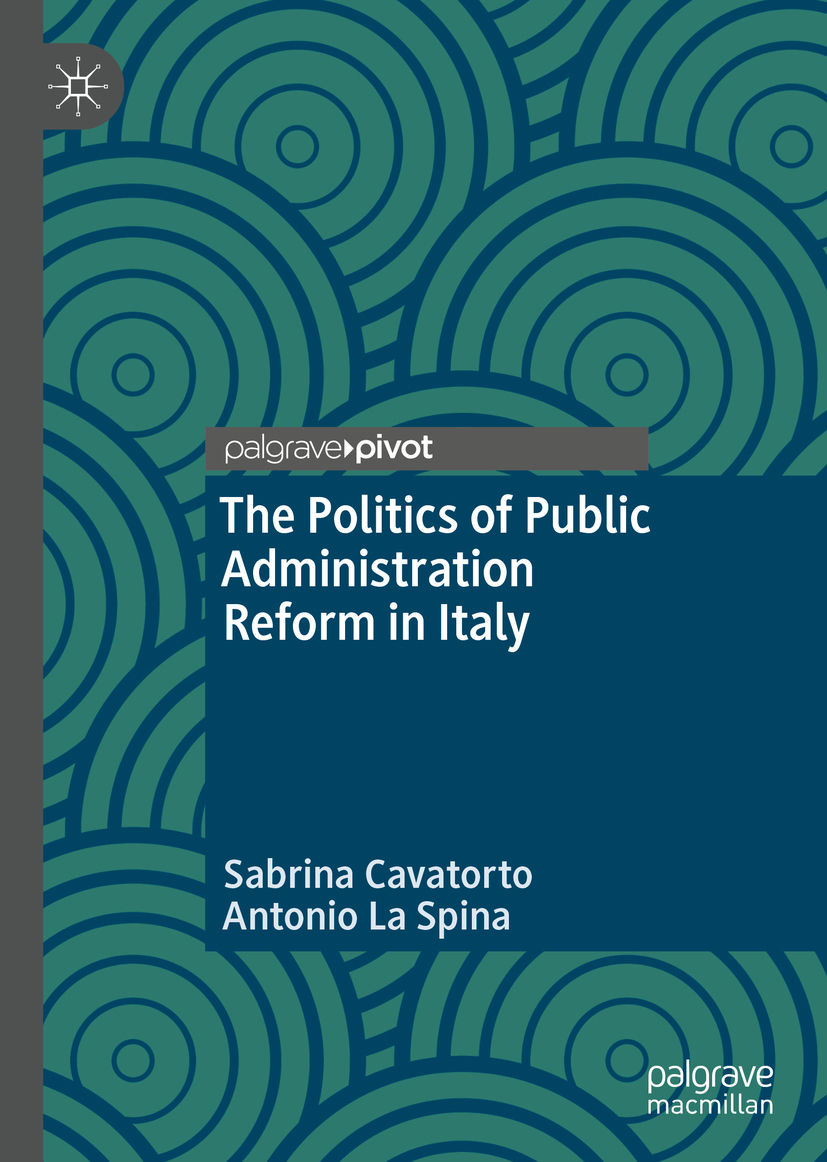
The Politics of Public Administration Reform in Italy This book provides a stimulating presentation of the Italian administrative system through an empirical and critical perspective on the processes of administrative reform at the national level. It focuses on some of the most recent changes developed during the years of austerity and fiscal crisis and offers an updated perspective on the attempts made by Italian governments to modernize national public administration through the ‘new public management’ and ‘governance’ paradigms. These frameworks have been suggested as models to enhance efficiency, transparency, accountability and public participation. The book studies international and supranational influence, policy diffusion, domestic politics and institutional dynamics, administrative traditions, and functional explanations—all determinants of policy outputs and outcomes, and possibly of policy learning as well. This book is the first to set out such a comprehensive and up-to-date analysis for non-Italian readers. POLITICAL SCIENCE,Public Policy,General

Partnerships for Livable Cities In this volume scholars from around the world discuss the innovative forms of collaboration between public and private actors that contribute to making our cities more liveable. It offers helpful insights into the practices of partnerships and the ways in which partnerships can contribute to a more liveable urban environment. The liveability of our cities is a topic of increasing relevance and urgency. The world’s cities are becoming congested and polluted, putting pressure on affordable housing and causing safety to become a major problem. Urban governments are unable to address these major challenges on their own, and thus they seek cooperation with other governments, companies, civil society organizations, and citizens. By focusing on examples such as greenery in the city, affordable housing, safety, neighbourhood revitalization, and ‘learning by doing’ in urban living labs, this book asks two key questions. How do partnerships between public and private actors contribute to the liveability of cities? Under what conditions are partnerships successful, and when do they fail to yield the desired results? POLITICAL SCIENCE,Public Policy,General
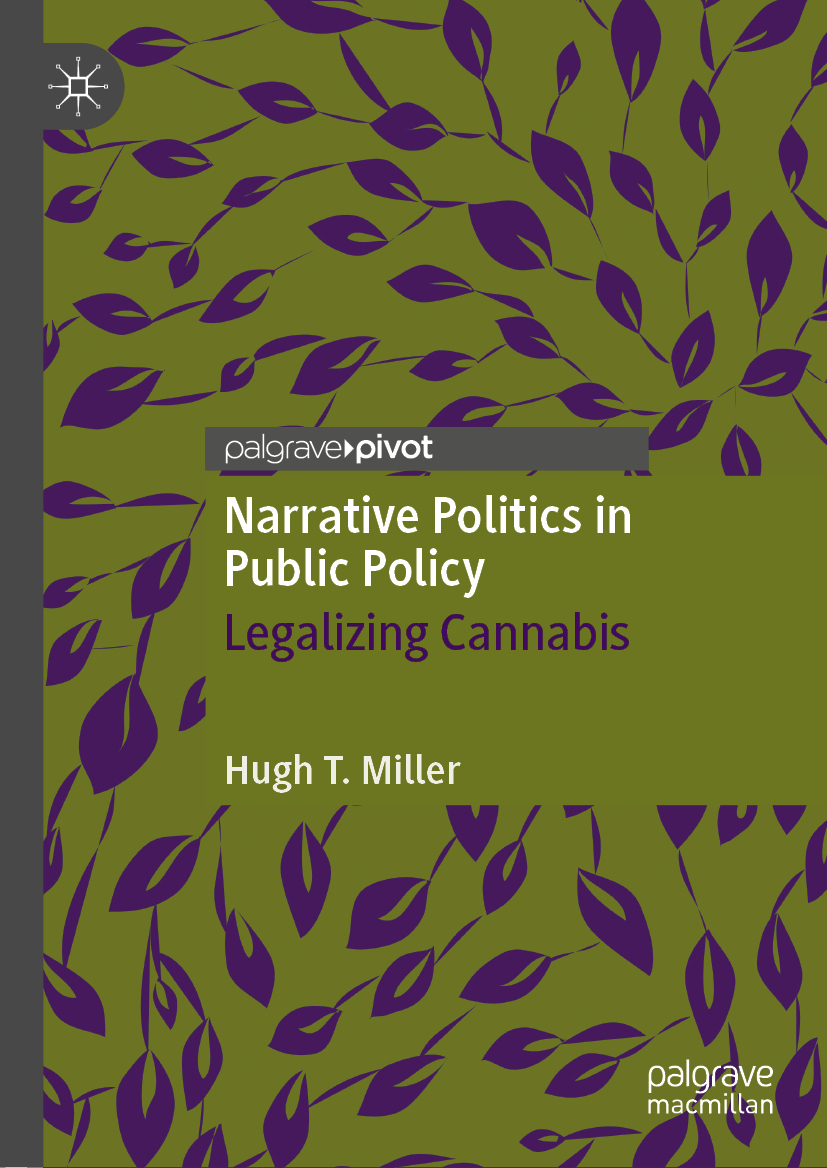
Narrative Politics in Public Policy This book draws on examples from cannabis policy discourse and elsewhere to illustrate how individuals come to subscribe to a particular policy narrative; how policy narratives evolve; how narratives are employed in public policy discourse to compete with other narratives; and how, on implementation, the winning narrative is performed and subsequently institutionalized. Further, it explores how uncertainty and ambiguity are constants in public policy discourse, and how different factions and groups pursue different goals and aspirations. In the current climate of political reality, disputable facts and contestable goals, this book shows how different coalitions and ideologies use narratives to compete for policy dominance. POLITICAL SCIENCE,Public Policy,General

The Politics of Adapting to Climate Change This book examines the political themes and policy perspectives related to, and influencing, climate change adaptation. It provides an informed primer on the politics of adaptation, a topic largely overlooked in the current scholarship and literature, and addresses questions such as why these politics are so important, what they mean, and what their implications are. The book also reviews various political texts on adaptation. POLITICAL SCIENCE,Public Policy,General
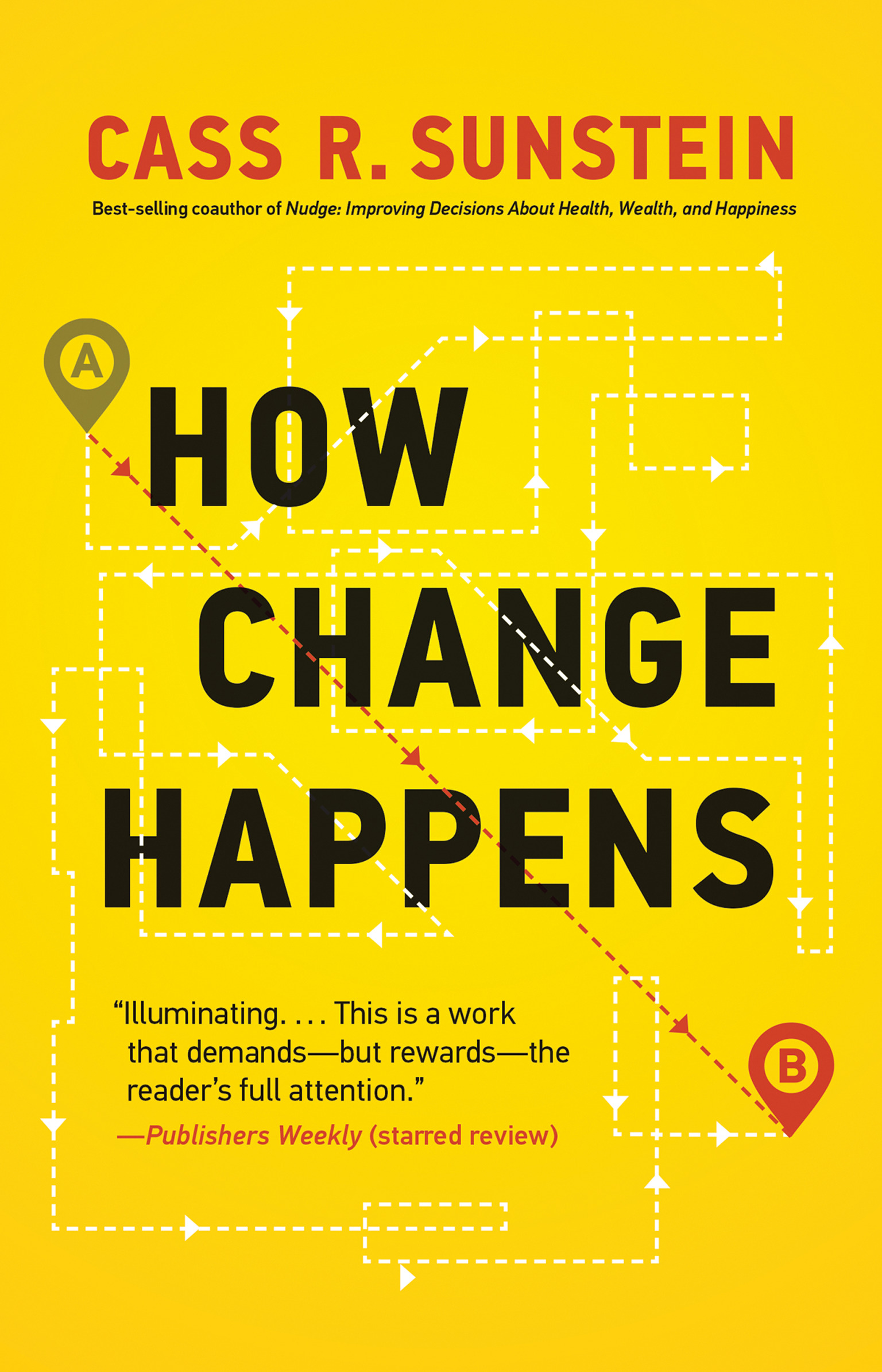
How Change Happens The different ways that social change happens, from unleashing to nudging to social cascades. "Sunstein's book is illuminating because it puts norms at the center of how we think about change."—David Brooks, The New York Times How does social change happen? When do social movements take off? Sexual harassment was once something that women had to endure; now a movement has risen up against it. White nationalist sentiments, on the other hand, were largely kept out of mainstream discourse; now there is no shortage of media outlets for them. In this book, with the help of behavioral economics, psychology, and other fields, Cass Sunstein casts a bright new light on how change happens. Sunstein focuses on the crucial role of social norms—and on their frequent collapse. When norms lead people to silence themselves, even an unpopular status quo can persist. Then one day, someone challenges the norm—a child who exclaims that the emperor has no clothes; a woman who says “me too.” Sometimes suppressed outrage is unleashed, and long-standing practices fall. Sometimes change is more gradual, as “nudges” help produce new and different decisions—apps that count calories; texted reminders of deadlines; automatic enrollment in green energy or pension plans. Sunstein explores what kinds of nudges are effective and shows why nudges sometimes give way to bans and mandates. Finally, he considers social divisions, social cascades, and “partyism,” when identification with a political party creates a strong bias against all members of an opposing party—which can both fuel and block social change. POLITICAL SCIENCE,Public Policy,General
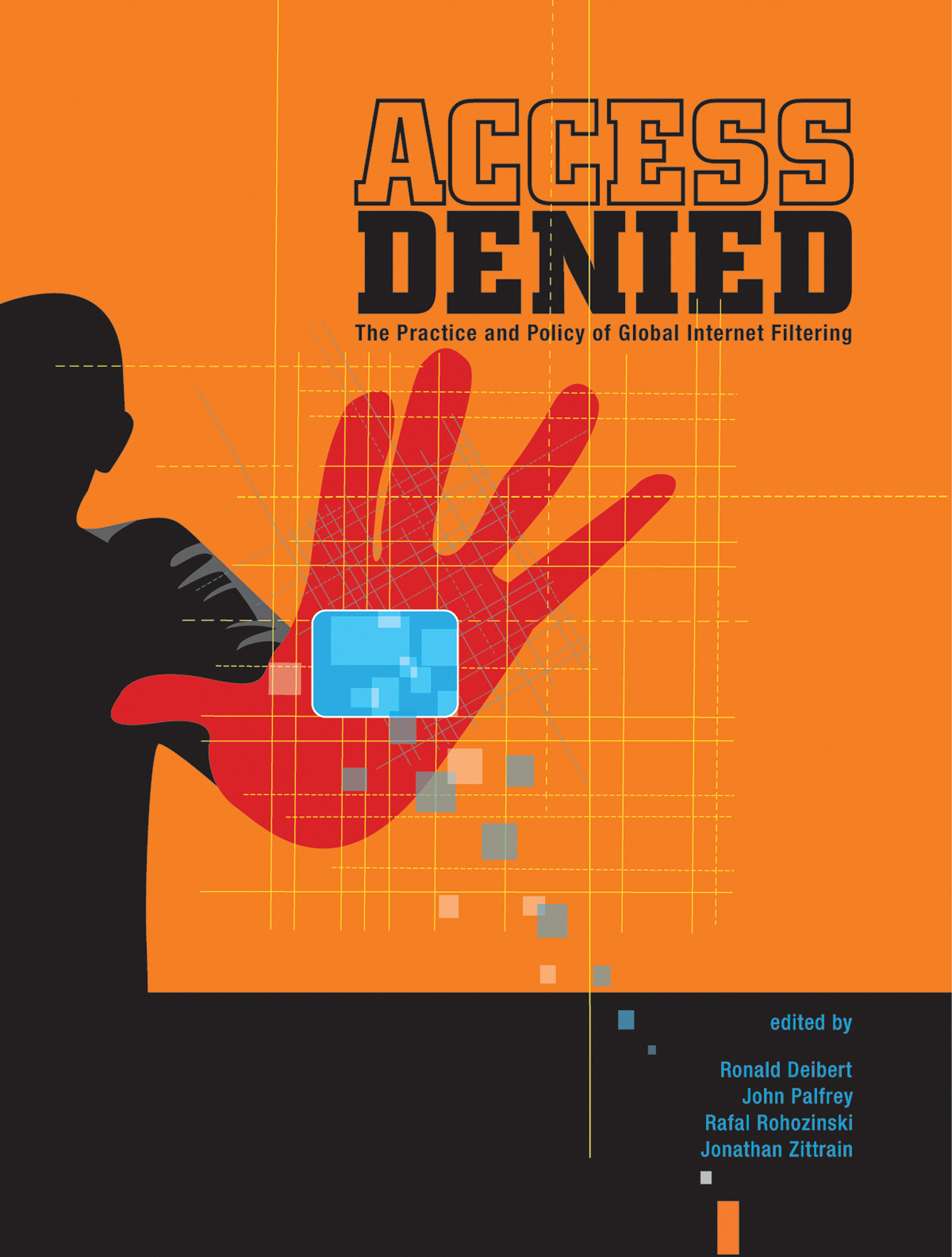
Access Denied A study of Internet blocking and filtering around the world: analyses by leading researchers and survey results that document filtering practices in dozens of countries. Many countries around the world block or filter Internet content, denying access to information that they deem too sensitive for ordinary citizens—most often about politics, but sometimes relating to sexuality, culture, or religion. Access Denied documents and analyzes Internet filtering practices in more than three dozen countries, offering the first rigorously conducted study of an accelerating trend. Internet filtering takes place in more than three dozen states worldwide, including many countries in Asia, the Middle East, and North Africa. Related Internet content-control mechanisms are also in place in Canada, the United States and a cluster of countries in Europe. Drawing on a just-completed survey of global Internet filtering undertaken by the OpenNet Initiative (a collaboration of the Berkman Center for Internet and Society at Harvard Law School, the Citizen Lab at the University of Toronto, the Oxford Internet Institute at Oxford University, and the University of Cambridge) and relying on work by regional experts and an extensive network of researchers, Access Denied examines the political, legal, social, and cultural contexts of Internet filtering in these states from a variety of perspectives. Chapters discuss the mechanisms and politics of Internet filtering, the strengths and limitations of the technology that powers it, the relevance of international law, ethical considerations for corporations that supply states with the tools for blocking and filtering, and the implications of Internet filtering for activist communities that increasingly rely on Internet technologies for communicating their missions. Reports on Internet content regulation in forty different countries follow, with each two-page country profile outlining the types of content blocked by category and documenting key findings. Contributors Ross Anderson, Malcolm Birdling, Ronald Deibert, Robert Faris, Vesselina Haralampieva [as per Rob Faris], Steven Murdoch, Helmi Noman, John Palfrey, Rafal Rohozinski, Mary Rundle, Nart Villeneuve, Stephanie Wang, Jonathan Zittrain POLITICAL SCIENCE,Public Policy,General
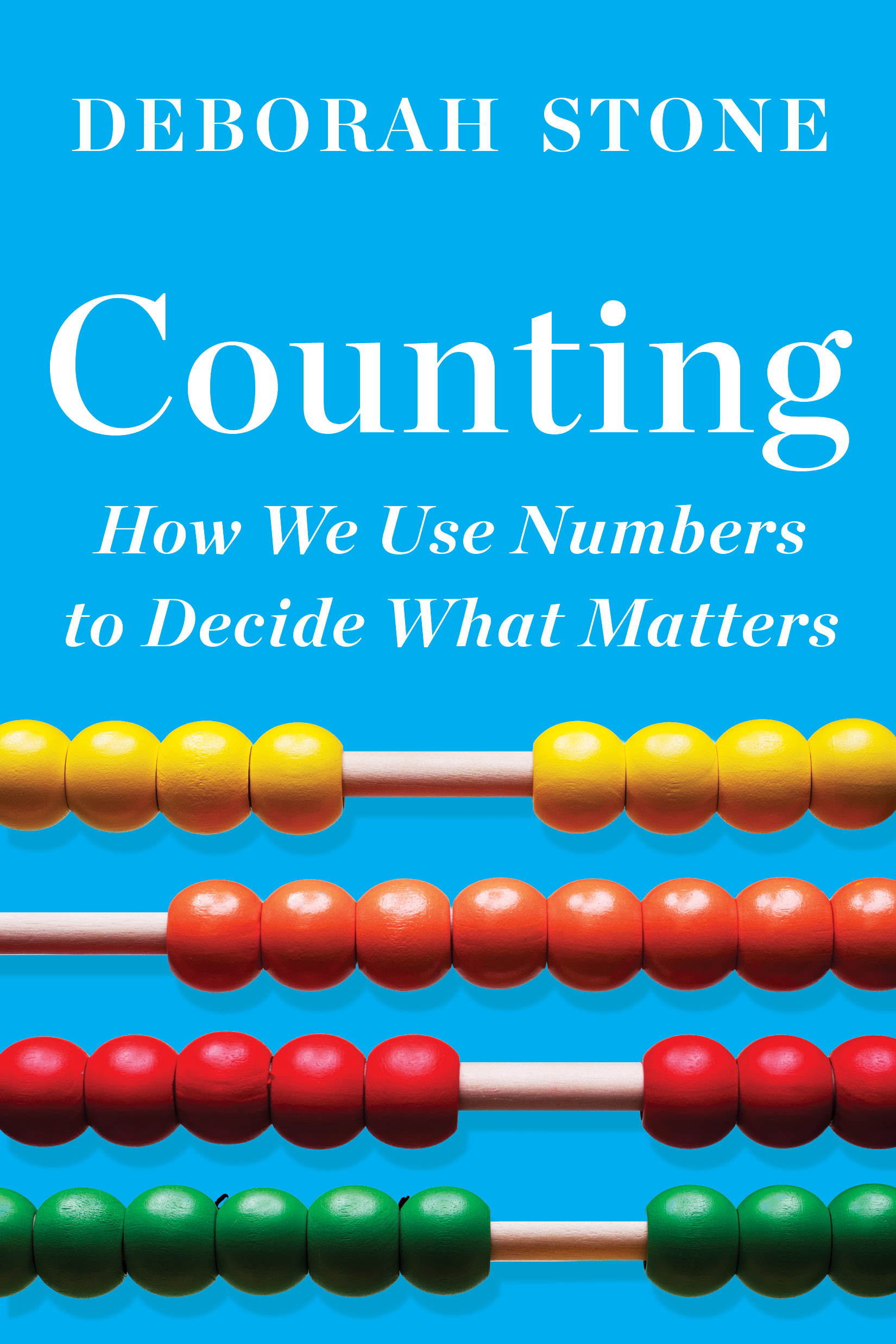
Counting “Deborah Stone’s mind-altering insight is that the numbers we use to capture the human experience are themselves a form of creative story-telling. They shouldn’t end the conversation, but spark a deeper and richer one. Counting deserves five stars for showing why five stars can never tell the whole story.†—Jacob S. Hacker, co-author of Let Them Eat Tweets: How the Right Rules in an Age of Extreme Inequality What do people do when they count? What do numbers really mean? We all know that people can lie with statistics, but in this groundbreaking work, eminent political scientist Deborah Stone uncovers a much deeper problem. With help from Dr. Seuss and Cookie Monster, she explains why numbers can’t be objective: in order to count, one must first decide what counts. Every number is the ending to a story built on cultural assumptions, social conventions, and personal judgments.And yet, in this age of big data and metric mania, numbers shape almost every facet of our lives: whether we get hired, fired, or promoted; whether we get into college or out of prison; how our opinions are gathered and portrayed to politicians; or how government designs health and safety regulations. In warm and playful prose, Counting explores what happens when we measure nebulous notions like merit, race, poverty, pain, or productivity. When so much rides on numbers, they can become instruments of social welfare, justice, and democracy—or not. The citizens of Flint, Michigan, for instance, used numbers to prove how their household water got contaminated and to force their government to take remedial action. In stark contrast, the Founding Fathers finessed an intractable conflict by counting each slave as three-fifths of a person in the national census. They set a terrible precedent for today’s politicians who claim to solve moral and political dilemmas with arithmetic. Suffused with moral reflection and ending with a powerful epilogue on COVID-19’s dizzying statistics, Counting will forever change our relationship with numbers. POLITICAL SCIENCE,Public Policy,General

Value Chains and WTO Disputes As economic populism and protectionism increasingly threatens the global trade order, this book examines the behavior of World Trade Organization (WTO) members at the judicial arm of the WTO—the dispute settlement mechanism (DSM). The author explores why and when governments cooperate at the WTO and comply with the ruling of its panels, focusing on how the growth of global value chains through the internationalization of trade and production has increased the importance of both trade liberalization and supra-national governance and policy-making. Finding that domestic organized interests—i.e. firms and sectors—mobilize and lobby national governments to change their domestic policies to better harmonize with their international trade commitments, the author outlines how the time it takes to comply with adverse WTO rulings is shorter when the potential domestic costs of non-compliance outweigh protectionist interests. The author’s innovative research design highlights the conditions under which the WTO can preserve the rules of international trade and support a more open, global economy. POLITICAL SCIENCE,Public Policy,General

A New Social Ontology of Government This book provides a better understanding of some of the central puzzles of empirical political science: how does “government†express will and purpose? How do political institutions come to have effective causal powers in the administration of policy and regulation? What accounts for both plasticity and perseverance of political institutions and practices? And how are we to formulate a better understanding of the persistence of dysfunctions in government and public administration – failures to achieve public goods, the persistence of self-dealing behavior by the actors of the state, and the apparent ubiquity of corruption even within otherwise high-functioning governments? POLITICAL SCIENCE,Public Policy,General

Innovation in Public Planning This book contributes to the discourse on planning theory by accentuating the perspective of public innovation. Extending planning theory's traditional two major perspectives - 'Communicate' and 'Calculate' - the book argues that contemporary planning theory should incorporate 'Innovate' as a third perspective. It highlights the multitude of new perspectives that innovative planning can bring to bear on planning theory, as well as showing how the interplay between the three perspectives - 'Communicate', 'Calculate' and 'Innovate' - can help to address vital issues in contemporary societal development. POLITICAL SCIENCE,Public Policy,General

Chinese Immigration and Australian Politics This book analyses how an increasing number of new Chinese migrants have integrated into Australian society and added a new dimension to Australian domestic politics as a result of Australia’s merit-based immigration system and its shift towards Asia. These policies have helped Australia sustain its growth without a recession for decades, but have also slowly changed established patterns in the distribution of job opportunities, wealth, and political influence in the country. These transformations have recently triggered a strong Sinophobic campaign in Australia, the most disturbing aspect of which is the denial of the successful integration of Chinese migrants into Australian society. Based on evidence gathered through a longitudinal study of Chinese migrants in Australia, this book examines the misconceptions troubling Australia’s current China debate from six important but overlooked perspectives, ranging from migration policy changes, economic factors, grassroots responses, the role of major political parties, community activism, to knowledge issues. POLITICAL SCIENCE,Public Policy,General

Land and Housing Controversies in Hong Kong This book discusses land and housing controversies in Hong Kong, which offer a point of reference for the comparison and analysis of similar or contrasting cases overseas from the perspective of social values. It enhances readers’ understanding of the social values, philosophical and theoretical issues that underpin land and housing controversies, as well as their policy implications. The discussion in each chapter goes beyond mere substantive and contextual analysis, and is explicitly positioned and theorized within the broader context of social values, with a theoretical and philosophical framework for assessing the issue concerned. The book is interdisciplinary in nature, with each chapter integrating two or more disciplines to examine various controversial land and housing issues. POLITICAL SCIENCE,Public Policy,General

Killing the American Dream As the US deports record numbers of illegal immigrants and local and state governments scramble to pass laws resembling dystopian police states where anyone can be questioned and neighbors are encouraged to report on one another, violent anti-immigration rhetoric is growing across the nation. Against this tide of hysteria, Pilar Marrero reveals how damaging this rise in malice toward immigrants is not only to the individuals, but to our country as a whole. Marrero explores the rise in hate groups and violence targeting the foreign-born from the 1986 Immigration Act to the increasing legislative madness of laws like Arizona's SB1070 which allows law officers to demand documentation from any individual with "reasonable suspicion" of citizenship, essentially encouraging states and municipalities to form their own self-contained nation-states devoid of immigrants. Assessing the current status quo of immigration, Marrero reveals the economic drain these ardent anti-immigration policies have as they deplete the nation of an educated work force, undermine efforts to stabilize tax bases and social security, and turn the American Dream from a time honored hallmark of the nation into an unattainable fantasy for all immigrants of the present and future. POLITICAL SCIENCE,Public Policy,Immigration
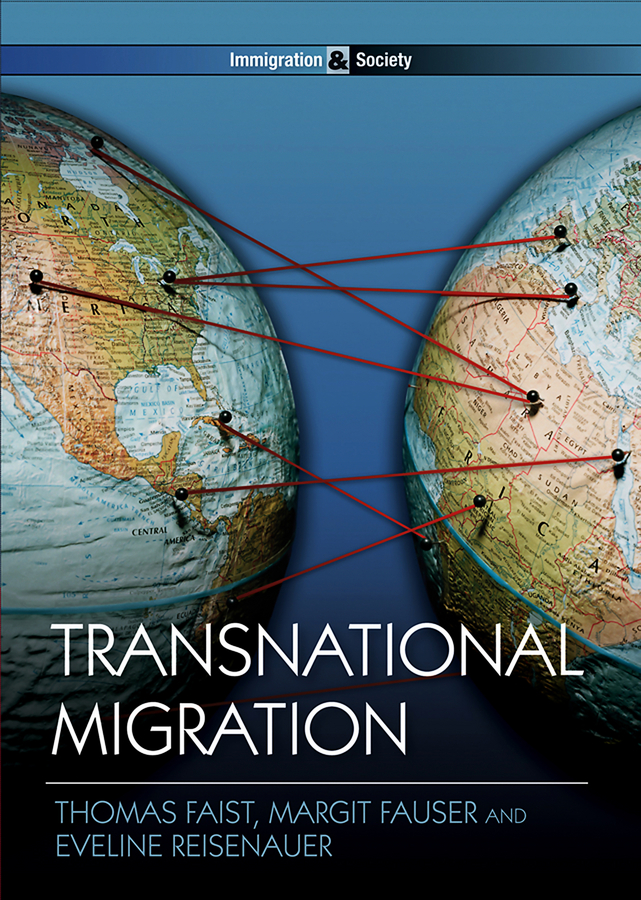
Transnational Migration Increasing interconnections between nation-states across borders have rendered the transnational a key tool for understanding our world. It has made particularly strong contributions to immigration studies and holds great promise for deepening insights into international migration. This is the first book to provide an accessible yet rigorous overview of transnational migration, as experienced by family and kinship groups, networks of entrepreneurs, diasporas and immigrant associations. As well as defining the core concept, it explores the implications of transnational migration for immigrant integration and its relationship to assimilation. By examining its political, economic, social, and cultural dimensions, the authors capture the distinctive features of the new immigrant communities that have reshaped the ethno-cultural mix of receiving nations, including the US and Western Europe. Importantly, the book also examines the effects of transnationality on sending communities, viewing migrants as agents of political and economic development. This systematic and critical overview of transnational migration perfectly balances theoretical discussion with relevant examples and cases, making it an ideal book for upper-level students covering immigration and transnational relations on sociology, political science, and globalization courses. POLITICAL SCIENCE,Public Policy,Immigration

Stranger “There are times when I feel like a stranger in this country. I am not complaining and it’s not for lack of opportunity. But it is something of a disappointment. I never would have imagined that after having spent thirty five years in the United States I would still be a stranger to so many. But that’s how it is”. Jorge Ramos, an Emmy award-winning journalist, Univision’s longtime anchorman and widely considered the “voice of the voiceless” within the Latino community, was forcefully removed from an Iowa press conference in 2015 by then-candidate Donald Trump after trying to ask about his plans on immigration. In this personal manifesto, Ramos sets out to examine what it means to be a Latino immigrant, or just an immigrant, in present-day America. Using current research and statistics, with a journalist’s nose for a story, and interweaving his own personal experience, Ramos shows us the changing face of America while also trying to find an explanation for why he, and millions of others, still feel like strangers in this country. “It is precisely this pattern of confrontation… that has won Ramos the trust of so many Hispanics. They know that in many countries south of the United States, direct questions can provoke not simply a loss of access but also a loss of life.” --Marcela Valdes, The New York Times POLITICAL SCIENCE,Public Policy,Immigration

The Politically Incorrect Guide to Immigration America’s immigration crisis is out of control! Unregulated immigration has led to an increase in crime, a loss of working class jobs, an inflated welfare state, and an elevated amount of terror threats on our home territory. The clash of differing emotions, facts, and opinions reveal that this issue is not simply a nationwide disagreement; it is an American crisis. In The Politically Incorrect Guide to Immigration, authors John Zmirak and Al Perrotta debunk the Left’s most deceptive myths on this complex policy issue – and reveal the huge implications that lie ahead for our nation’s future. Zmirak and Perrotta set the record straight on the history of American immigration, uncover the principles with which our forefathers migrated to America, affirm the respect with which migrants should treat our country if they wish to live here, and assert real solutions to the immigration crisis America faces. The Politically Incorrect Guide to Immigration equips readers with real-life statistics and information, and is packed with targeted arguments to help convince even the staunchest advocates for open borders that America needs to build “The Wall.†You may think you know all about immigration, but in The Politically Incorrect Guide to Immigration you’ll learn: • Building “The Wall†would cost less than half of what we spend to educate illegal immigrants every year • Illegal immigration costs American taxpayers $116 billion a year • 62% of naturalized immigrants are for the Democrats; only 25% are for the Republicans • Competition from immigrants costs American worker $450 billion a year • The Founders wanted to admit only immigrants who would make a net contribution—and assimilate • Millions of nineteenth-century immigrants who couldn’t make it in American went back home • The percent of foreign-born in the United States today is the highest since World War I—and this time we’re not doing “Americanization†• After Reagan’s 1986 Amnesty the illegal population went from 3.2 million to 11 million • Over 700,000 foreign visitors to the United States in 2016 overstayed their visas • Eighty percent of Central American women and girls who enter the United States illegally are raped along the way • Non-citizens are only 9 percent of our population but 27 percent of federal prisoners • One hundred forty-seven million more people from around the world would like to move to the United States POLITICAL SCIENCE,Public Policy,Immigration

Sand and Blood A damning portrait of the U.S.-Mexico border, where militaristic fantasies are unleashed, violent technologies are tested, and immigrants are targeted. Over the past three decades, U.S. immigration and border security policies have turned the southern states into conflict zones, spawned a network of immigrant detention centers, and unleashed an army of ICE agents into cities across the country. As award-winning journalist John Carlos Frey reveals in this groundbreaking book, the war against immigrants has been escalating for decades, fueled by defense contractors and lobbyists seeking profits and politicians--Republicans and Democrats alike--who relied on racist fear-mongering to turn out votes. After 9/11, while Americans' attention was trained on the Middle East and the wars in Iraq and Afghanistan, the War on Terror was ramping up on our own soil--aimed not at terrorists but at economic migrants, refugees, and families from South and Central America seeking jobs, safety, and freedom in the U.S. But we are no safer. Instead, families are being ripped apart, undocumented people are living in fear, and thousands of migrants have died in detention or crossing the border. Taking readers to the Border Patrol outposts, unmarked graves, detention centers, and halls of power, Sand and Blood is a frightening, essential story we must not ignore. POLITICAL SCIENCE,Public Policy,Immigration

Border Wars Two New York Times Washington correspondents provide a detailed, “ fact-based account of what precipitated some of this administration’s more brazen assaults on immigration†(The Washington Post) filled with never-before-told stories of this key issue of Donald Trump’s presidency. No issue matters more to Donald Trump and his administration than restricting immigration. Julie Hirschfeld Davis and Michael D. Shear have covered the Trump administration from its earliest days. In Border Wars, they take us inside the White House to document how Stephen Miller and other anti-immigration officials blocked asylum-seekers and refugees, separated families, threatened deportation, and sought to erode the longstanding bipartisan consensus that immigration and immigrants make positive contributions to America. Their revelation of Trump’s desire for a border moat filled with alligators made national news. As the authors reveal, Trump has used immigration to stoke fears (“the caravanâ€), attack Democrats and the courts, and distract from negative news and political difficulties. As he seeks reelection in 2020, Trump has elevated immigration in the imaginations of many Americans into a national crisis. Border Wars identifies the players behind Trump’s anti-immigration policies, showing how they planned, stumbled and fought their way toward changes that have further polarized the nation. “[Davis and Shear’s] exquisitely reported Border Wars reveals the shattering horror of the moment, [and] the mercurial unreliability and instability of the president†(The New York Times Book Review). POLITICAL SCIENCE,Public Policy,Immigration

No Justice in the Shadows This provocative account of our immigration system's long, racist history reveals how it has become the brutal machine that upends the lives of millions of immigrants today. Each year in the United States, hundreds of thousands of people are arrested, imprisoned, and deported, trapped in what leading immigrant rights activist and lawyer Alina Das calls the "deportation machine." The bulk of the arrests target people who have a criminal record -- so-called "criminal aliens" -- the majority of whose offenses are immigration-, drug-, or traffic-related. These individuals are uprooted and banished from their homes, their families, and their communities. Through the stories of those caught in the system, Das traces the ugly history of immigration policy to explain how the U.S. constructed the idea of the "criminal alien," effectively dividing immigrants into the categories "good" and "bad," "deserving" and "undeserving." As Das argues, we need to confront the cruelty of the machine so that we can build an inclusive immigration policy premised on human dignity and break the cycle once and for all. POLITICAL SCIENCE,Public Policy,Immigration
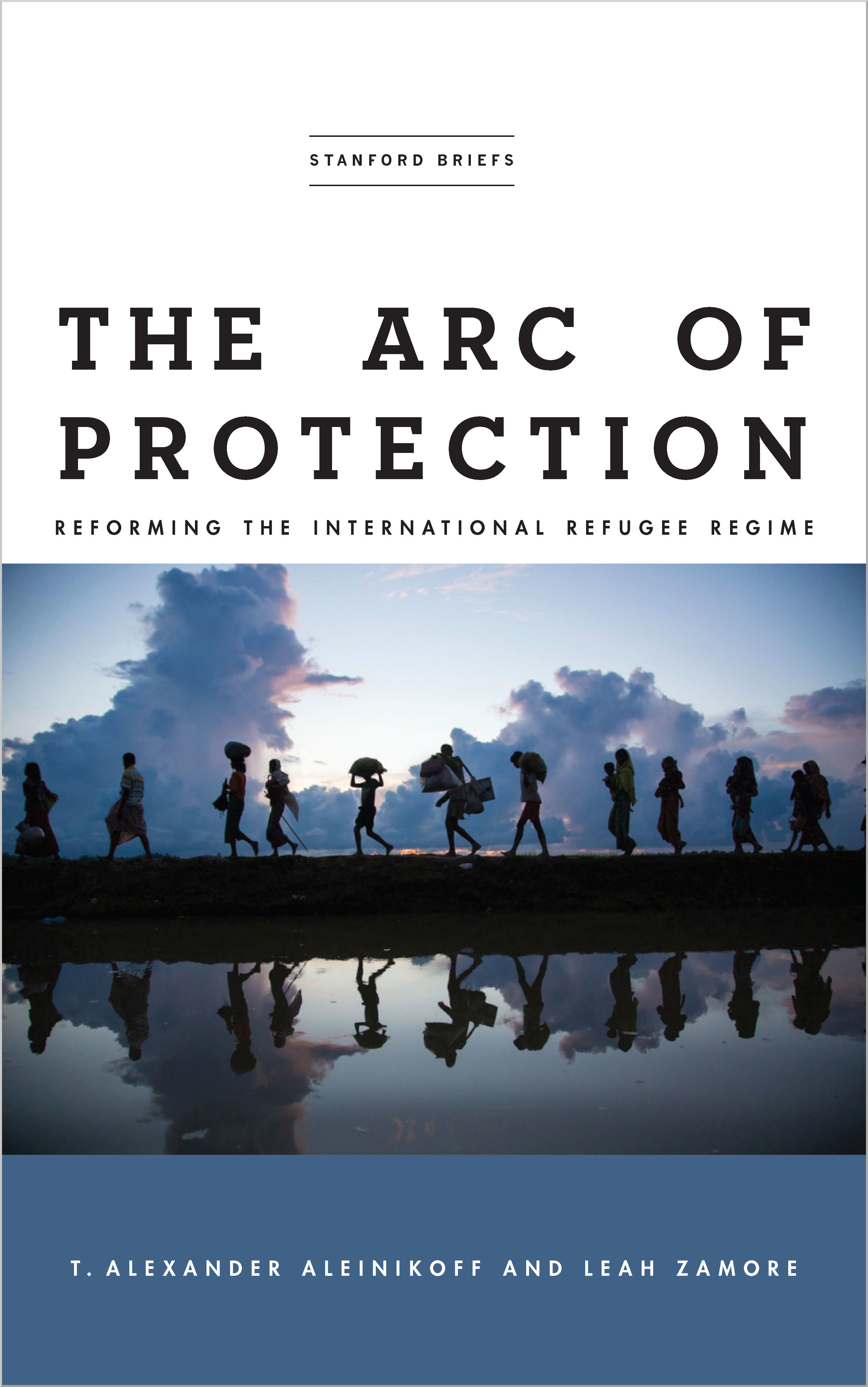
The Arc of Protection The international refugee regime is fundamentally broken. Designed in the wake of World War II to provide protection and assistance, the system is unable to address the record numbers of persons displaced by conflict and violence today. States have put up fences and adopted policies to deny, deter, and detain asylum seekers. People recognized as refugees are routinely denied rights guaranteed by international law. The results are dismal for the millions of refugees around the world who are left with slender prospects to rebuild their lives or contribute to host communities. T. Alexander Aleinikoff and Leah Zamore lay bare the underlying global crisis of responsibility. The Arc of Protection adopts a revisionist and critical perspective that examines the original premises of the international refugee regime. Aleinikoff and Zamore identify compromises at the founding of the system that attempted to balance humanitarian ideals and sovereign control of their borders by states. This book offers a way out of the current international morass through refocusing on responsibility-sharing, seeing the humanitarian-development divide in a new light, and putting refugee rights front and center. POLITICAL SCIENCE,Public Policy,Immigration

Making Immigrants in Modern Argentina In Making Immigrants in Modern Argentina, Julia AlbarracÃn argues that modern Argentina's selection of immigrants lies at the intersection of state decision-making processes and various economic, cultural, and international factors. Immediately after independence, Argentina designed a national project for the selection of Western European immigrants in order to build an economically viable society, but also welcomed many local Latin Americans, as well as Jewish and Middle Eastern immigrants. Today, Argentines are quick to blame Latin American immigrants for crime, drug violence, and an increase in the number of people living in shantytowns. AlbarracÃn discusses how the current Macri administration, possibly emulating the Trump administration's immigration policies, has rolled back some of the rights awarded to immigrants by law in 2003 through an executive order issued in 2017. AlbarracÃn explains the roles of the executive and legislative branches in enacting new policies and determines the weight of numerous factors throughout this process. Additionally, AlbarracÃn puts Argentine immigration policies into a comparative perspective and creates space for new ways to examine countries other than those typically discussed. Incorporating a vast amount of research spanning 150 years of immigration policies, five decades of media coverage of immigration, surveys with congresspersons, and interviews with key policy makers, AlbarracÃn goes beyond the causes and consequences of immigration to assess the factors shaping policy decisions both in the past and in modern Argentina. This book will appeal to scholars, students, and general readers with an interest in immigration, democratization, race, history, culture, nationalism, Latin American studies, and representation of minorities in the media. POLITICAL SCIENCE,Public Policy,Immigration
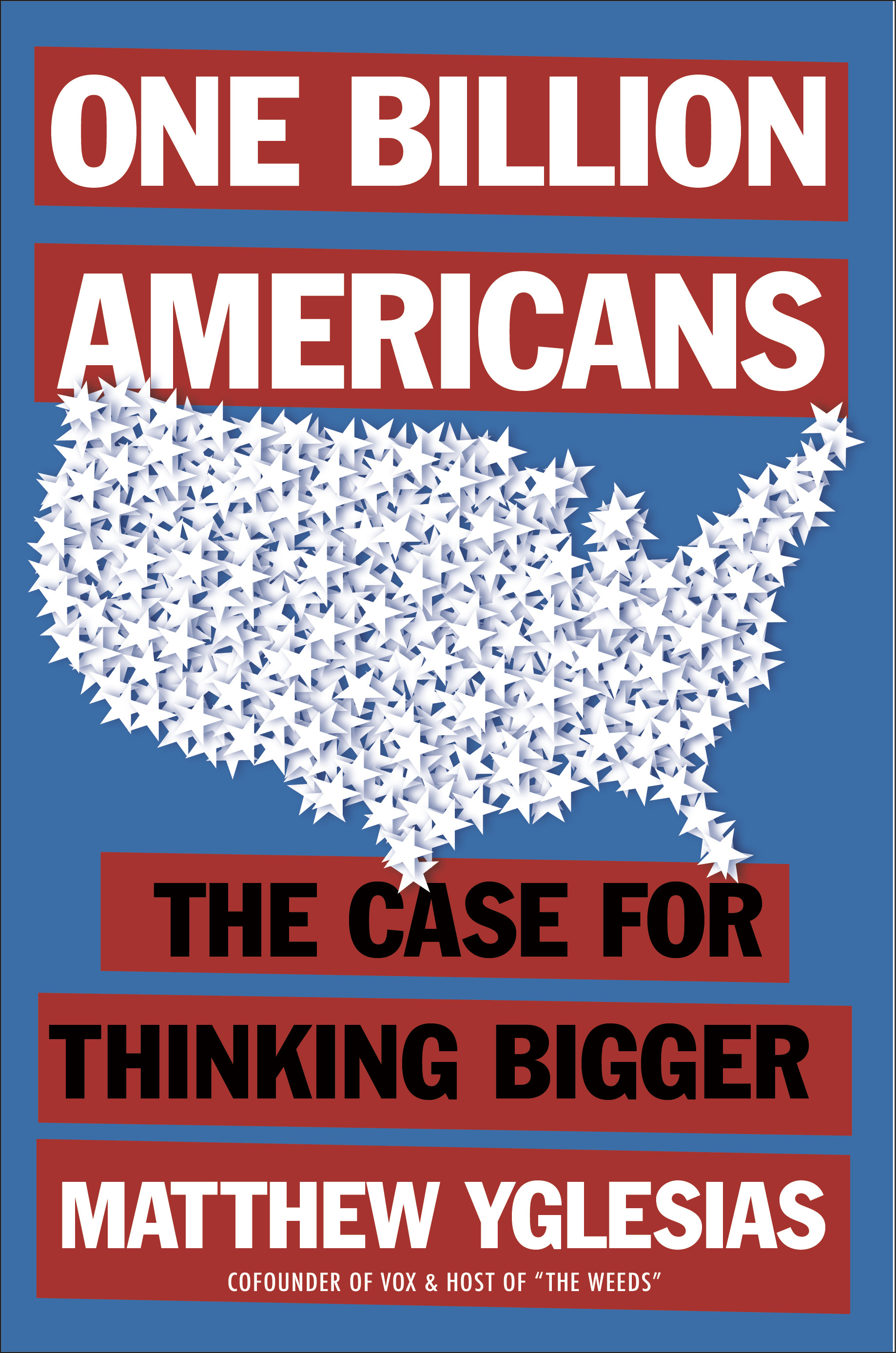
One Billion Americans NATIONAL BESTSELLER What would actually make America great: more people. If the most challenging crisis in living memory has shown us anything, it’s that America has lost the will and the means to lead. We can’t compete with the huge population clusters of the global marketplace by keeping our population static or letting it diminish, or with our crumbling transit and unaffordable housing. The winner in the future world is going to have more—more ideas, more ambition, more utilization of resources, more people. Exactly how many Americans do we need to win? According to Matthew Yglesias, one billion. From one of our foremost policy writers, One Billion Americans is the provocative yet logical argument that if we aren’t moving forward, we’re losing. Vox founder Yglesias invites us to think bigger, while taking the problems of decline seriously. What really contributes to national prosperity should not be controversial: supporting parents and children, welcoming immigrants and their contributions, and exploring creative policies that support growth—like more housing, better transportation, improved education, revitalized welfare, and climate change mitigation. Drawing on examples and solutions from around the world, Yglesias shows not only that we can do this, but why we must. Making the case for massive population growth with analytic rigor and imagination, One Billion Americans issues a radical but undeniable challenge: Why not do it all, and stay on top forever? POLITICAL SCIENCE,Public Policy,Immigration
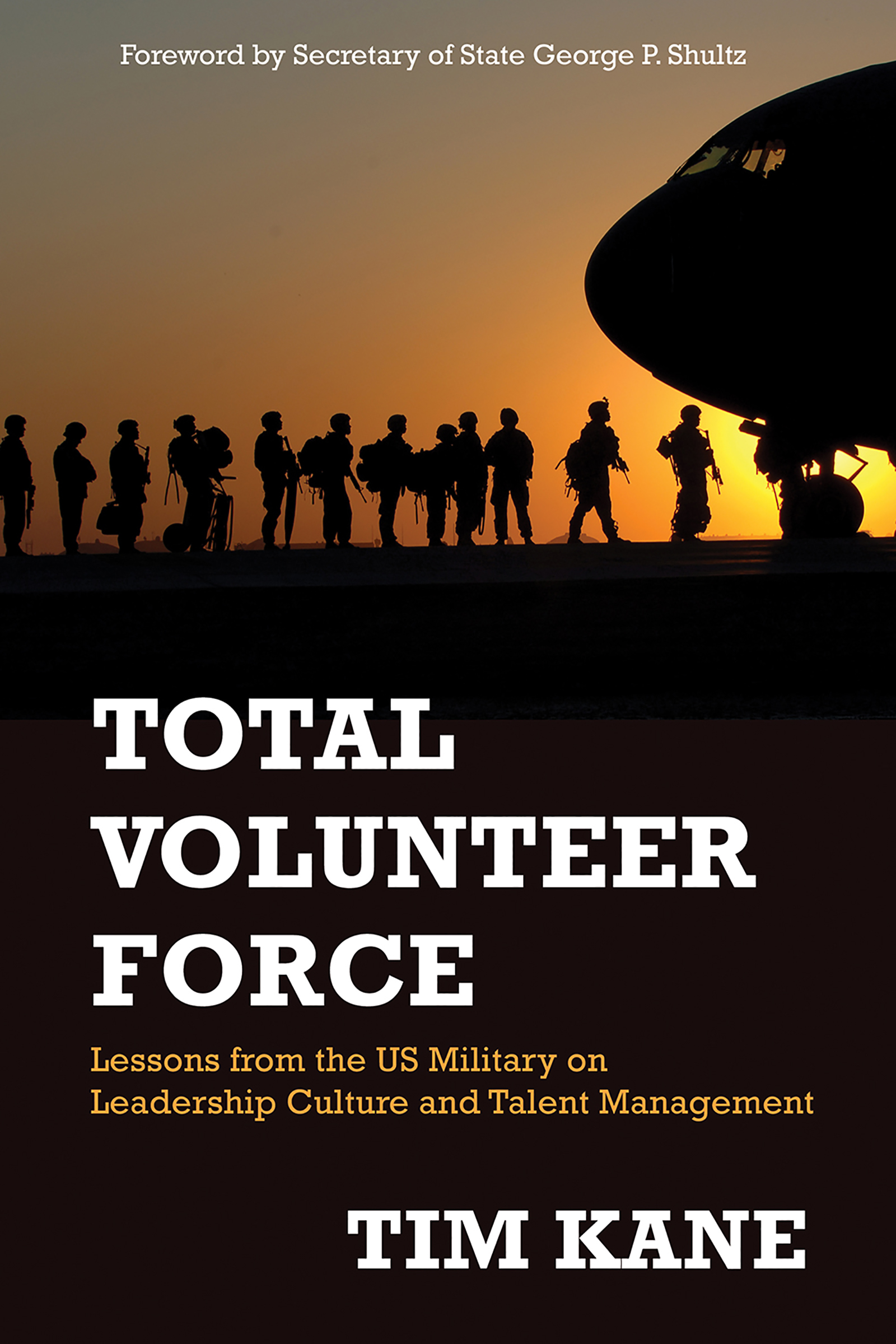
Total Volunteer Force Tim Kane analyzes the strengths and weaknesses of the US armed forces leadership culture and personnel management. He proposes a blueprint for reform that empowers troops as well as local commanders. Kane's proposals extend the All-Volunteer Force reforms of 1973 further along the spectrum of volunteerism, emphasize greater individual agency during all stages of a US military career, and restore diversity among the services. The Leader/Talent Matrix–an analytic framework Kane develops in the book–offers a multidimensional view of an organization's personnel practices. A survey of hundreds of veterans and active-duty troops reveals world-class strengths in the US armed forces leadership culture but a wide array of weaknesses in talent management. The Total Volunteer Force returns autonomy to the army, navy, air force, and Marine Corps. Kane offers an array of reforms to improve performance evaluations, create a talent market for job-matching, and revolutionize compensation to better reward merit and skill. POLITICAL SCIENCE,Public Policy,Military Policy
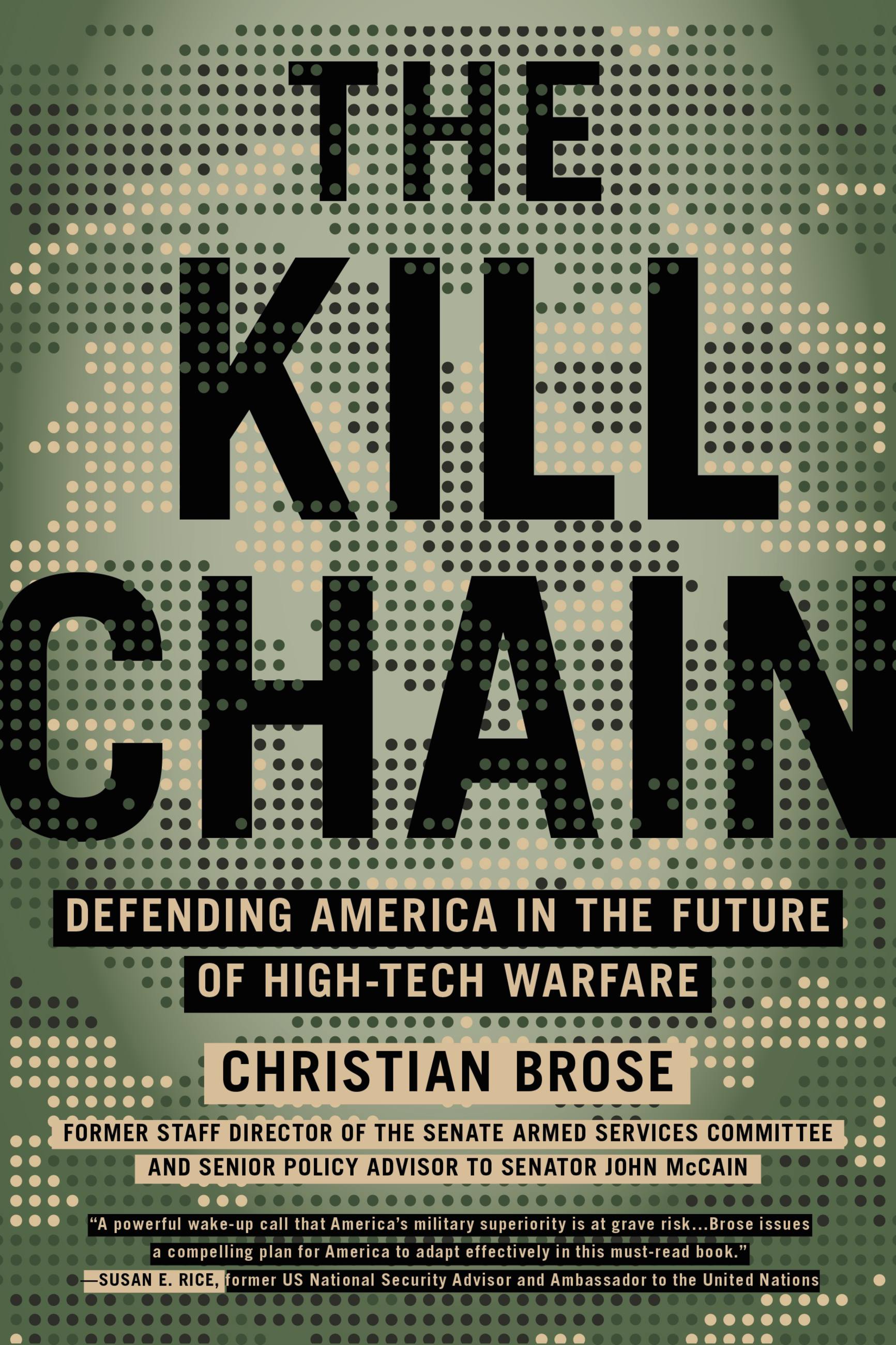
The Kill Chain For generations of Americans, our country has been the world's dominant military power. How the US military fights, and the systems and weapons that it fights with, have been uncontested. That old reality, however, is rapidly deteriorating. America's traditional sources of power are eroding amid the emergence of new technologies and the growing military threat posed by rivals such as China. America is at grave risk of losing a future war. As Christian Brose reveals in this urgent wake-up call, the future will be defined by artificial intelligence, autonomous systems, and other emerging technologies that are revolutionizing global industries and are now poised to overturn the model of American defense. This fascinating, if disturbing, book confronts the existential risks on the horizon, charting a way for America's military to adapt and succeed with new thinking as well as new technology. America must build a battle network of systems that enables people to rapidly understand threats, make decisions, and take military actions, the process known as "the kill chain." Examining threats from China, Russia, and elsewhere, The Kill Chain offers hope and, ultimately, insights on how America can apply advanced technologies to prevent war, deter aggression, and maintain peace. POLITICAL SCIENCE,Public Policy,Military Policy

To Start a War “Authoritative . . . The most comprehensive account yet of that smoldering wreck of foreign policy, one that haunts us today.” -Los Angeles Times “A timely reminder of the dangers of embarking upon wars that can imperil America itself.” -The New York Times From the author of the New York Times bestseller Dead Certain comes the definitive, revelatory reckoning with arguably the most consequential decision in the history of American foreign policy--the decision to invade Iraq. Even now, after more than fifteen years, it is hard to see the invasion of Iraq through the cool, considered gaze of history. For too many people, the damage is still too palpable, and still unfolding. Most of the major players in that decision are still with us, and few of them are not haunted by it, in one way or another. Perhaps it's that combination, the passage of the years and the still unresolved trauma, that explains why so many protagonists opened up so fully for the first time to Robert Draper. Draper's prodigious reporting has yielded scores of consequential new revelations, from the important to the merely absurd. As a whole, the book paints a vivid and indelible picture of a decision-making process that was fatally compromised by a combination of post-9/11 fear and paranoia, rank naïveté, craven groupthink, and a set of actors with idées fixes who gamed the process relentlessly. Everything was believed; nothing was true. The intelligence failure was comprehensive. Draper's fair-mindedness and deep understanding of the principal actors suffuse his account, as does a storytelling genius that is close to sorcery. There are no cheap shots here, which makes the ultimate conclusion all the more damning. In the spirit of Barbara Tuchman's The Guns of August and Marc Bloch's Strange Defeat, To Start A War will stand as the definitive account of a collective process that arrived at evidence that would prove to be not just dubious but entirely false, driven by imagination rather than a quest for truth--evidence that was then used to justify a verdict that led to hundreds of thousands of deaths and a flood tide of chaos in the Middle East that shows no signs of ebbing. POLITICAL SCIENCE,Public Policy,Military Policy
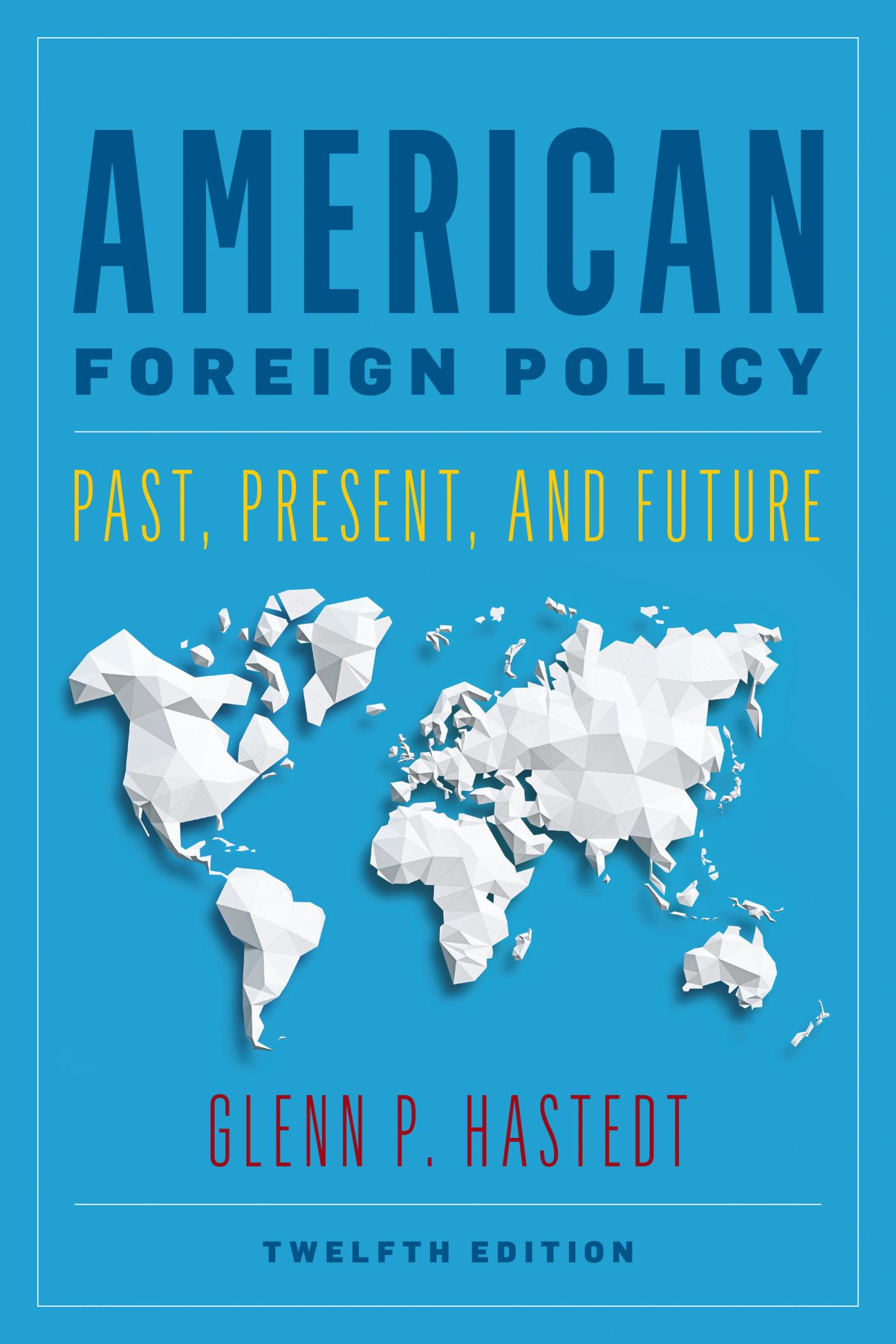
American Foreign Policy Hastedt introduces students to America’s changing role in the world and provides them with the critical thinking skills needed to participate in the debate about the conduct and content of American foreign policy. POLITICAL SCIENCE,Public Policy,Military Policy

The Violent American Century “Tells how America, since the end of World War II, has turned away from its ideals and goodness to become a match setting the world on fire†(Seymour Hersh, investigative journalist and national security correspondent). World War II marked the apogee of industrialized “total war.†Great powers savaged one another. Hostilities engulfed the globe. Mobilization extended to virtually every sector of every nation. Air war, including the terror bombing of civilians, emerged as a central strategy of the victorious Anglo-American powers. The devastation was catastrophic almost everywhere, with the notable exception of the United States, which exited the strife unmatched in power and influence. The death toll of fighting forces plus civilians worldwide was staggering. The Violent American Century addresses the US-led transformations in war conduct and strategizing that followed 1945—beginning with brutal localized hostilities, proxy wars, and the nuclear terror of the Cold War, and ending with the asymmetrical conflicts of the present day. The military playbook now meshes brute force with a focus on non-state terrorism, counterinsurgency, clandestine operations, a vast web of overseas American military bases, and—most touted of all—a revolutionary new era of computerized “precision†warfare. In contrast to World War II, postwar death and destruction has been comparatively small. By any other measure, it has been appalling—and shows no sign of abating. The author, recipient of a Pulitzer Prize and a National Book Award, draws heavily on hard data and internal US planning and pronouncements in this concise analysis of war and terror in our time. In doing so, he places US policy and practice firmly within the broader context of global mayhem, havoc, and slaughter since World War II—always with bottom-line attentiveness to the human costs of this legacy of unceasing violence. “Dower delivers a convincing blow to publisher Henry Luce’s benign ‘American Century’ thesis.†—Publishers Weekly POLITICAL SCIENCE,Public Policy,Military Policy
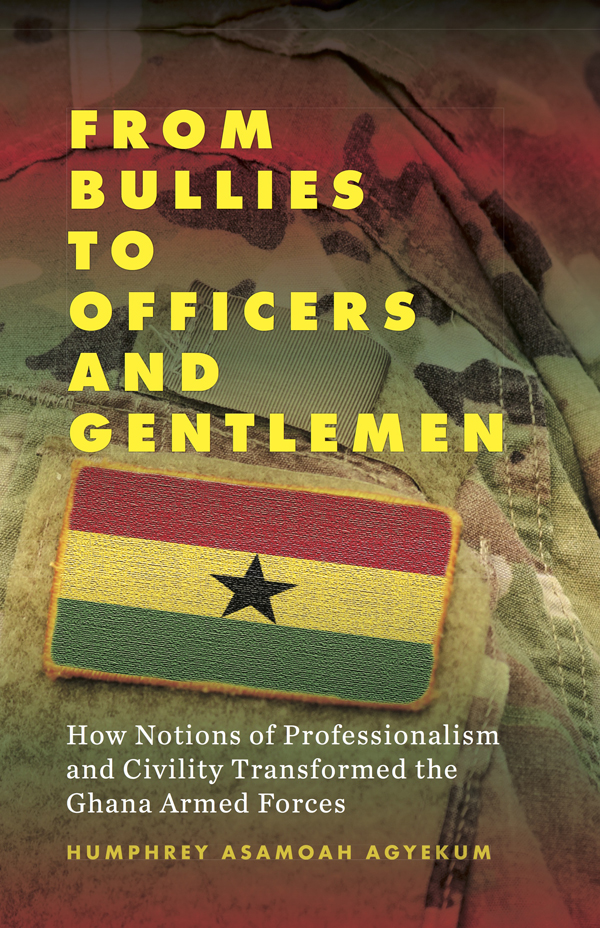
From Bullies to Officers and Gentlemen Based on unprecedented access to the Ghanaian military barracks and inspired by the recent resurgence of coups in West Africa, Agyekum assesses why and how the Ghana Armed Forces were transformed from an organization that actively orchestrated coups into an institution that accepts the authority of the democratically elected civilian government. Focusing on the process of professionalization of the Ghanaian military, this ethnography based monograph examines both historical and contemporary themes, and assesses the shift in military personnel from ‘Buga Buga’ soldiers – uneducated, lower-class soldiers, human rights abusers – to a more ‘modern’ fighting force. POLITICAL SCIENCE,Public Policy,Military Policy

Arms, Revenue, and Entitlements Arms, Revenue, and Entitlements: U.S. Deficits in the Cold War, 1945-1991 explores how defense, tax, and entitlement policies caused the U.S. government to become deficit normative during the Cold War era, arguing that only a comprehensive program can rein in deficits in the twenty-first century. POLITICAL SCIENCE,Public Policy,Military Policy
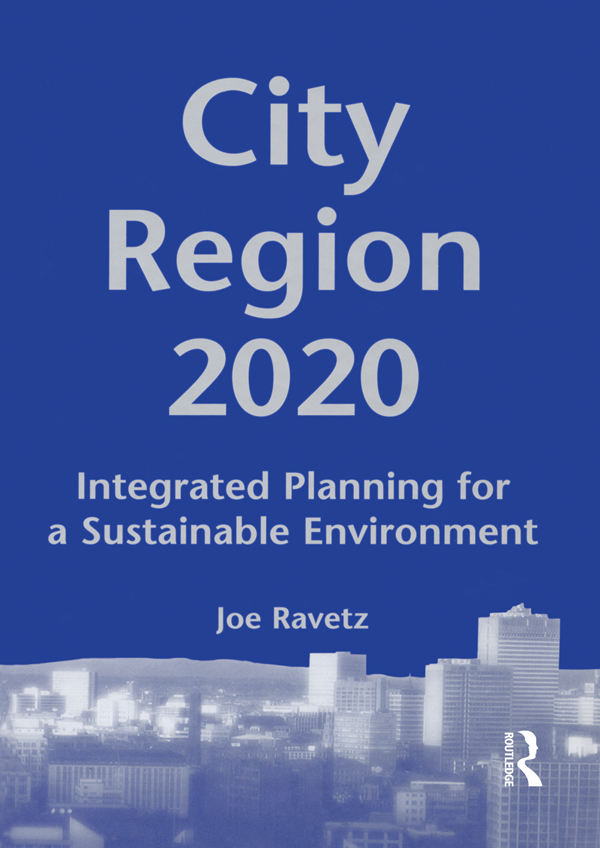
City-Region 2020 Based on analysis of the Manchester city-region, this book offers a vision of a sustainable urban future, through integrated strategic management of the entire city-region. It translates principles into practice for achieving the necessary balance to ensure a higher standard of living and safe environment. The text presents: a 25-year horizon for the evolution and restructuring of the urban system; a focus for linkages and synergies between economic, social and environmental sectors; technical scenarios for land use, energy and material flows; spatial scenarios for each area and settlement type; and lateral thinking on cultural, information, localization and globalization trends. Also included are practical actions, methods and tools such as sustainability indicators and appraisals that can be applied anywhere in the western world. POLITICAL SCIENCE,Public Policy,Regional Planning
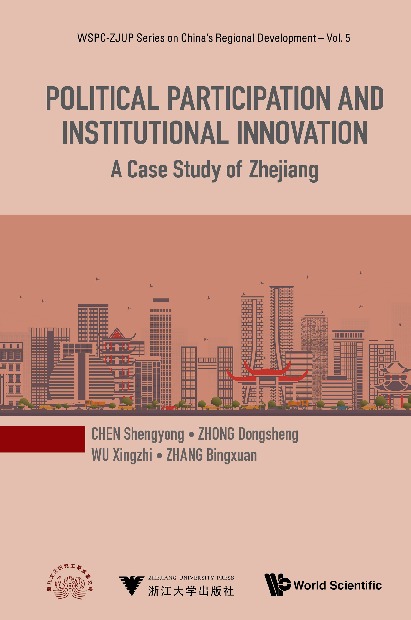
Political Participation And Institutional Innovation The participation of citizens in democratic politics serves as an indicator to measure a country's development, its political modernization and political civilization.To promote citizens' political participation, it is important to have them participate extensively in local governance and exercise their constitutional rights. This book analyses Zhejiang's experience in democratic consultation, hearing, people's proposal solicitation system, television and Internet political consultation, official and citizen dialogue on government websites. It studies how common people can actively participate in politics and manage the public affairs of the country through institutionalized ways and means. POLITICAL SCIENCE,Public Policy,Regional Planning

Radical Technologies A field manual to the technologies that are transforming our lives Everywhere we turn, a startling new device promises to transfigure our lives. But at what cost? In this urgent and revelatory excavation of our Information Age, leading technology thinker Adam Greenfield forces us to reconsider our relationship with the networked objects, services and spaces that define us. It is time to re-evaluate the Silicon Valley consensus determining the future. We already depend on the smartphone to navigate every aspect of our existence. We’re told that innovations—from augmented-reality interfaces and virtual assistants to autonomous delivery drones and self-driving cars—will make life easier, more convenient and more productive. 3D printing promises unprecedented control over the form and distribution of matter, while the blockchain stands to revolutionize everything from the recording and exchange of value to the way we organize the mundane realities of the day to day. And, all the while, fiendishly complex algorithms are operating quietly in the background, reshaping the economy, transforming the fundamental terms of our politics and even redefining what it means to be human. Having successfully colonized everyday life, these radical technologies are now conditioning the choices available to us in the years to come. How do they work? What challenges do they present to us, as individuals and societies? Who benefits from their adoption? In answering these questions, Greenfield’s timely guide clarifies the scale and nature of the crisis we now confront —and offers ways to reclaim our stake in the future. POLITICAL SCIENCE,Public Policy,Science & Technology Policy
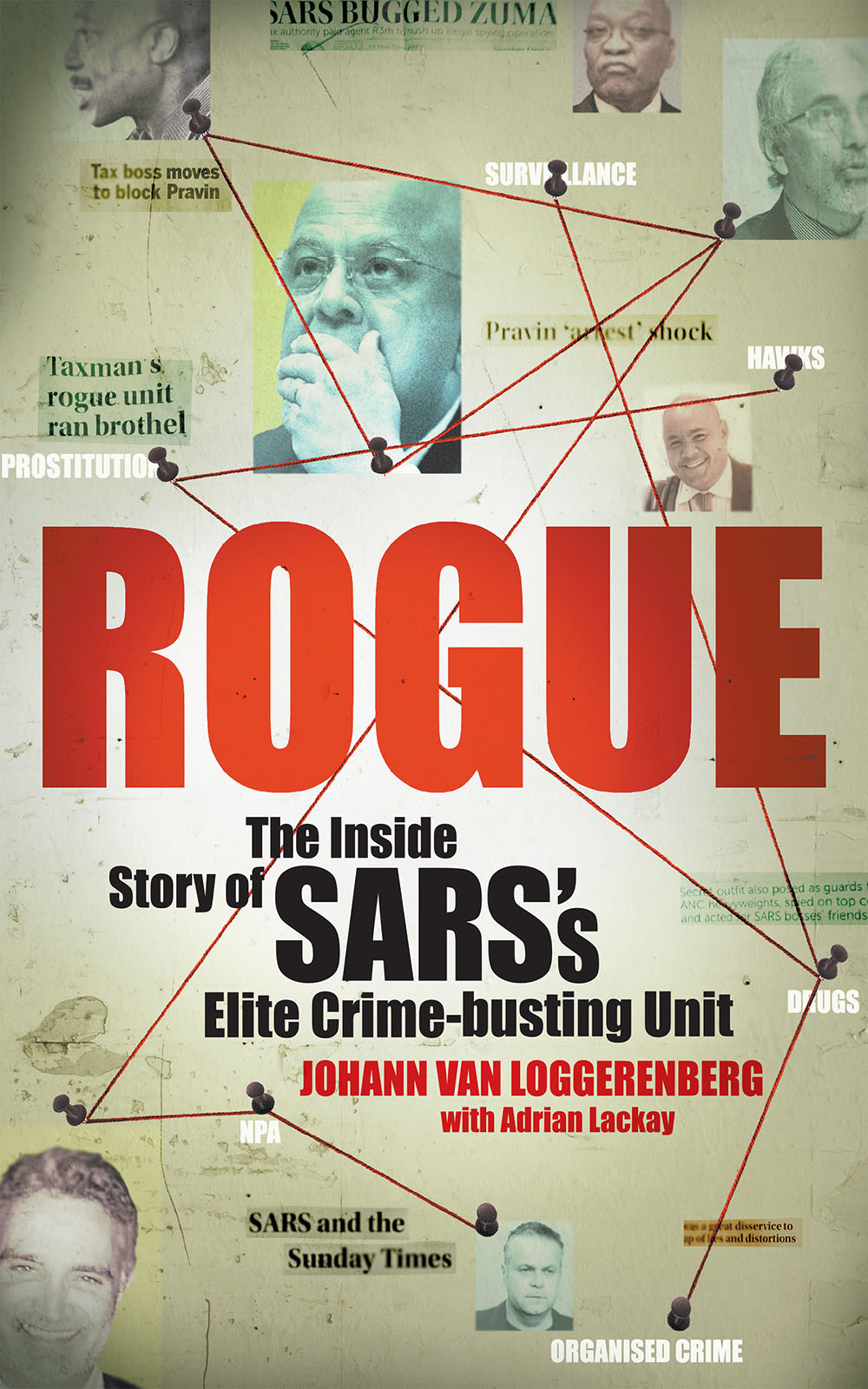
Rogue The story of a ‘rogue unit’ operating within the South African Revenue Service (SARS) became entrenched in the public mind following a succession of sensational reports published by the Sunday Times in 2014. The unit, the reports claimed, had carried out a series of illegal spook operations: they had spied on President Jacob Zuma, run a brothel, illegally bought spyware and entered into unlawful tax settlements. In a plot of Machiavellian proportions, head of the elite crime-busting unit Johann van Loggerenberg and many of SARS’s top management were forced to resign. Van Loggerenberg’s select team of investigators, with their impeccable track record of busting high-level financial fraudsters and nailing tax criminals, lost not only their careers but also their reputations.Now, in this extraordinary account, they finally get to put the record straight and the rumours to rest: there was no ‘rogue unit’. The public had been deceived, seemingly by powers conspiring to capture SARS for their own ends. Shooting down the allegations he has faced one by one, Van Loggerenberg tells the story of what really happened inside SARS, revealing details of some of the unit’s actual investigations. POLITICAL SCIENCE,Public Policy,Science & Technology Policy
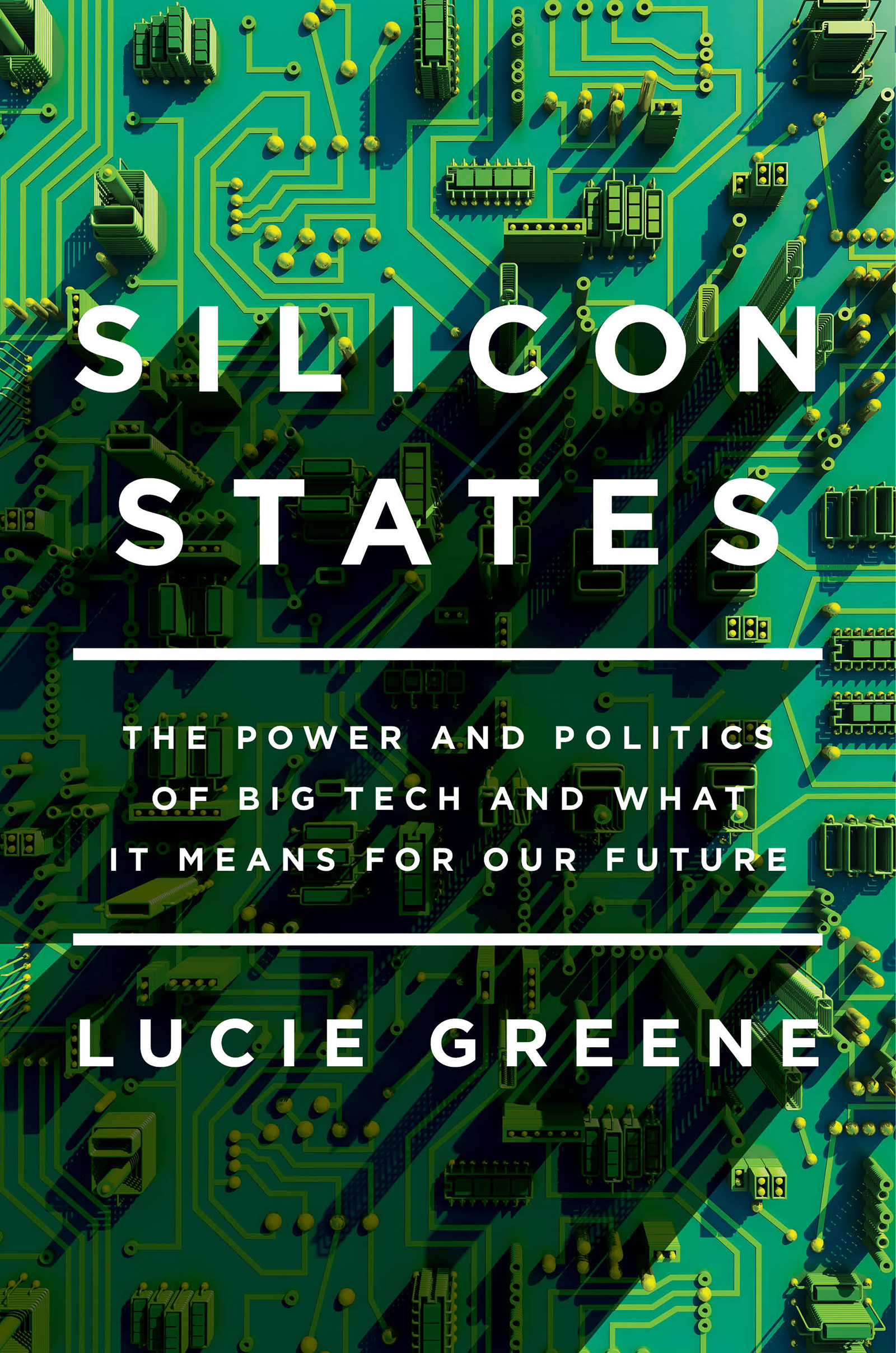
Silicon States Named a Best Book of the Year by Esquire Winner of the 800-CEO-READ Business Book Award in Current Events and Public Affairs A bracing look at how Google, Apple, Amazon, Facebook, and other Silicon Valley power players are using their influence across the globe to encroach upon our civil landscape. POLITICAL SCIENCE,Public Policy,Science & Technology Policy
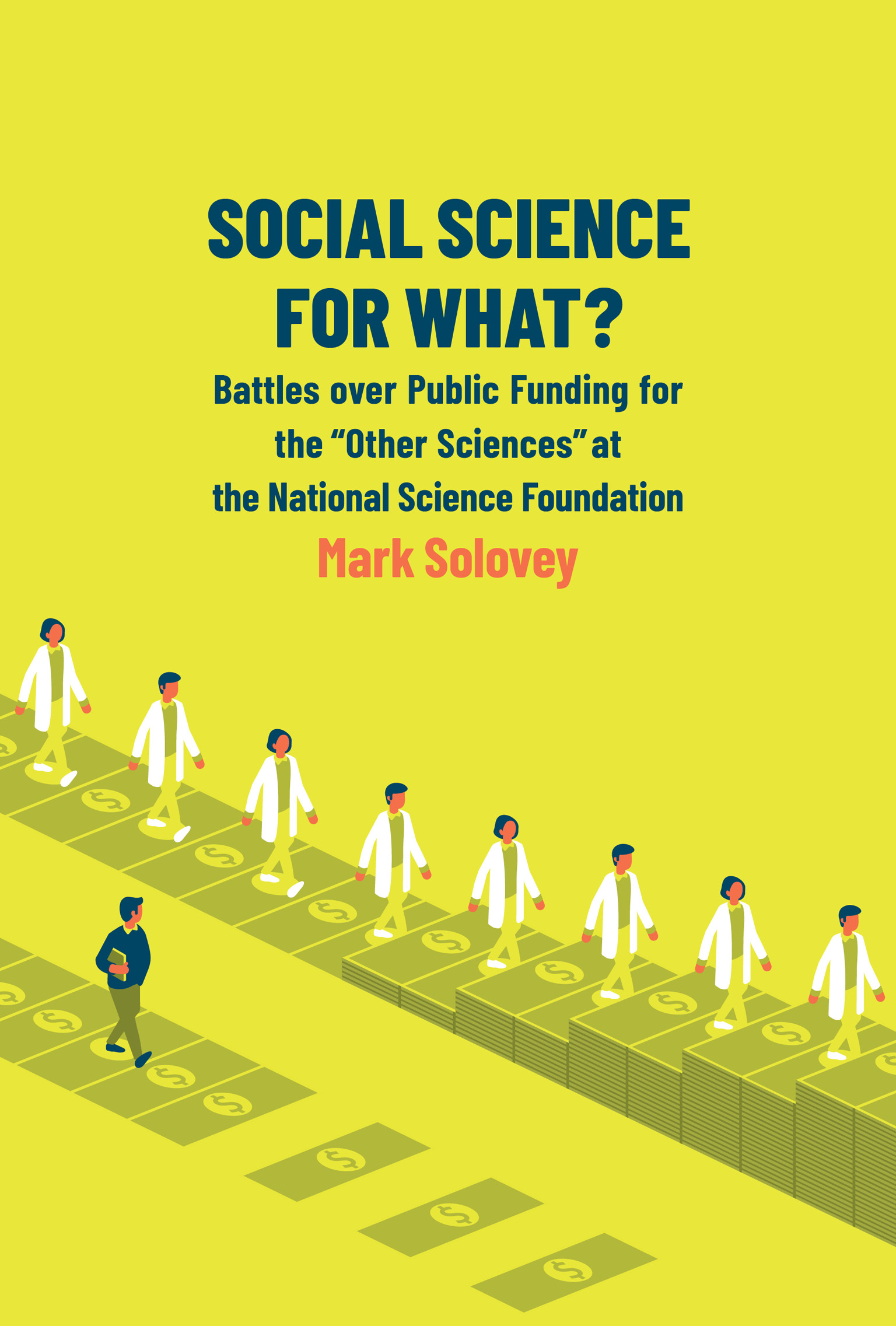
Social Science for What? How the NSF became an important yet controversial patron for the social sciences, influencing debates over their scientific status and social relevance. In the early Cold War years, the U.S. government established the National Science Foundation (NSF), a civilian agency that soon became widely known for its dedication to supporting first-rate science. The agency's 1950 enabling legislation made no mention of the social sciences, although it included a vague reference to "other sciences." Nevertheless, as Mark Solovey shows in this book, the NSF also soon became a major--albeit controversial--source of public funding for them. POLITICAL SCIENCE,Public Policy,Science & Technology Policy
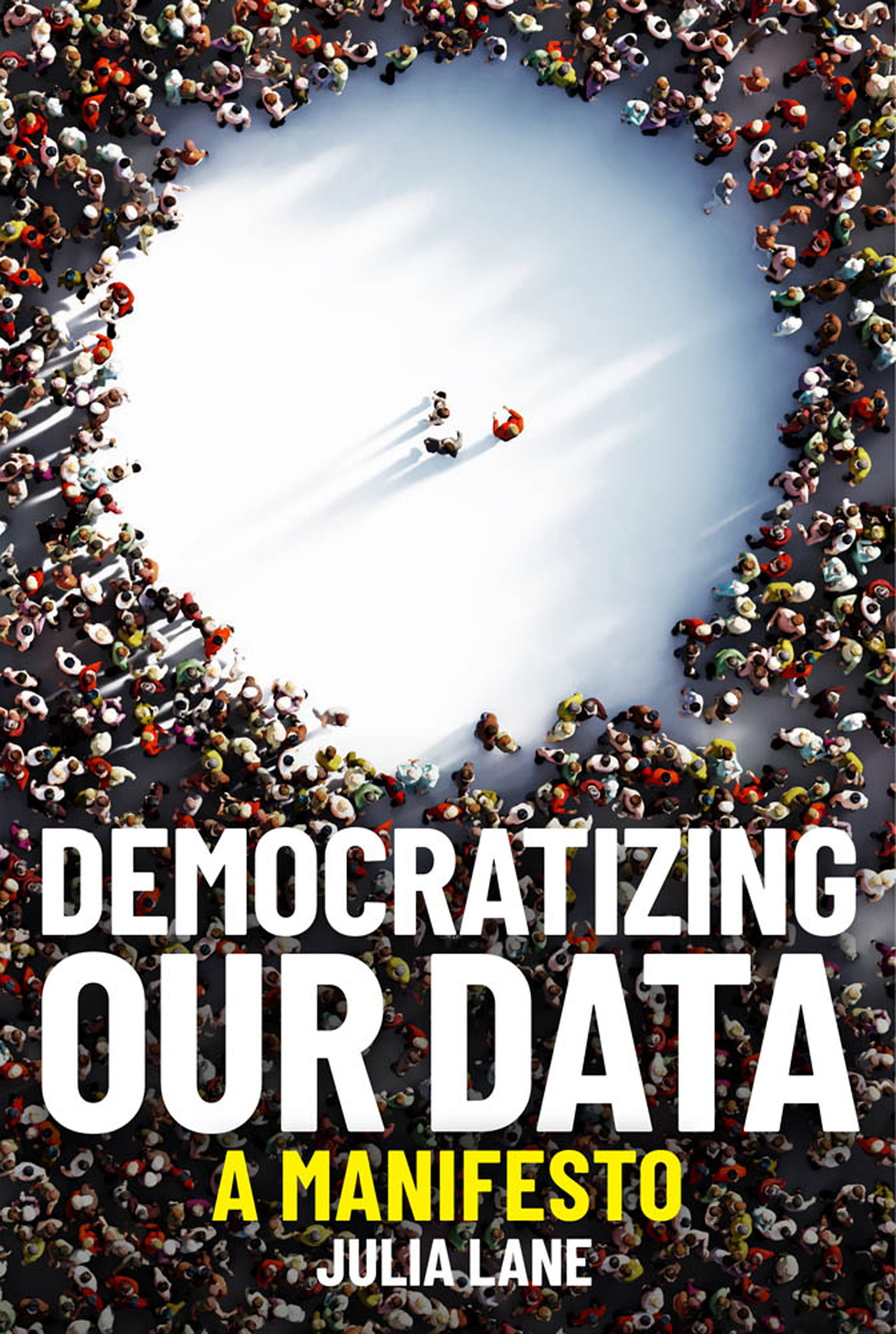
Democratizing Our Data Why America's data system is broken, and how to fix it. Why, with data increasingly important, available, valuable and cheap, are the data produced by the American government getting worse and costing more? State and local governments rely on population data from the US Census Bureau; prospective college students and their parents can check data from the National Center for Education Statistics; small businesses can draw on data about employment and wages from the Bureau of Labor Statistics. But often the information they get is out of date or irrelevant, based on surveys--a form of information gathering notorious for low response rates. In A Data Manifesto, Julia Lane argues that bad data is bad for democracy. Her book is a wake-up call to America to fix its broken public data system. POLITICAL SCIENCE,Public Policy,Science & Technology Policy
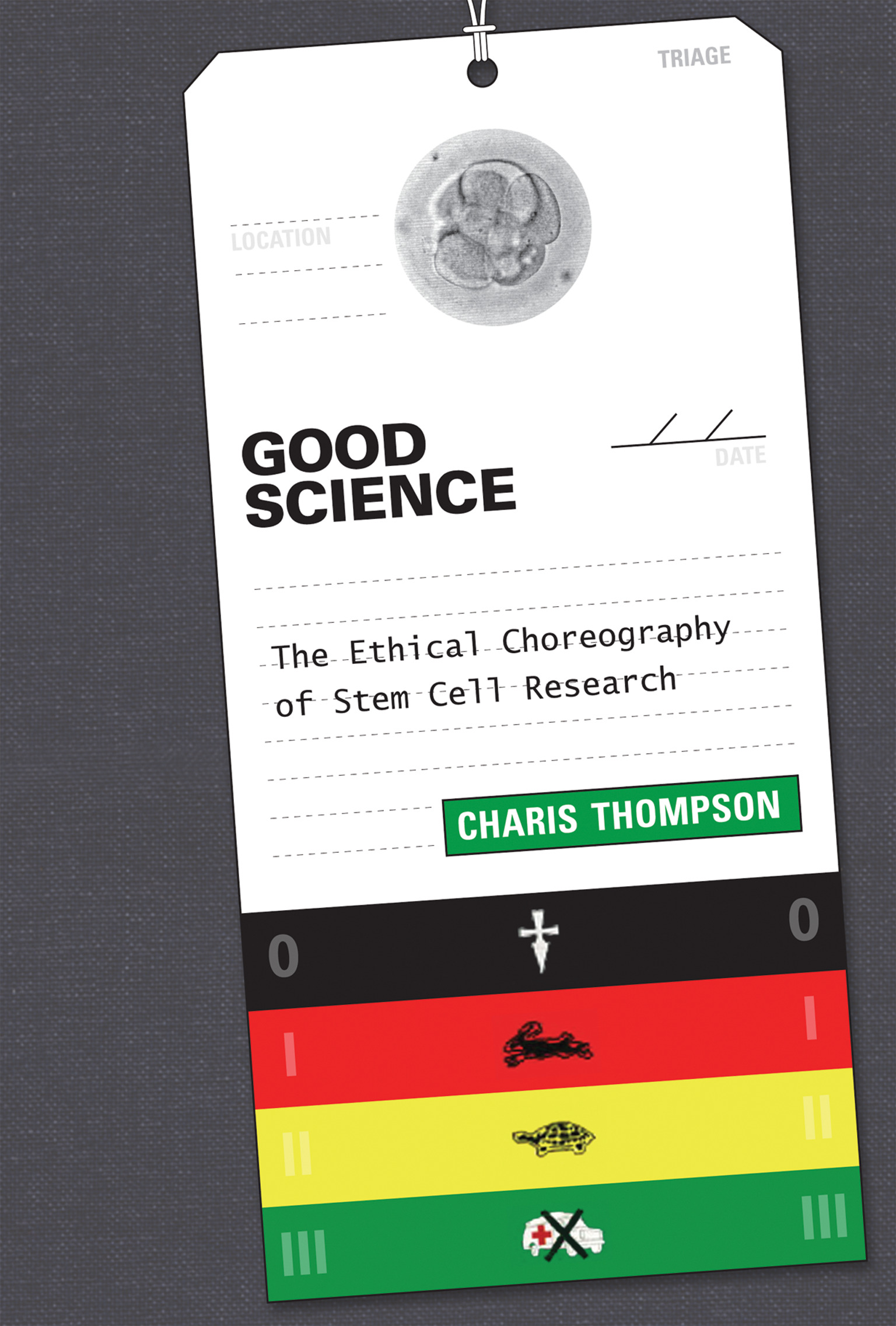
Good Science An examination of a decade and a half of political controversy, ethical debate, and scientific progress in stem cell research. After a decade and a half, human pluripotent stem cell research has been normalized. There may be no consensus on the status of the embryo—only a tacit agreement to disagree—but the debate now takes place in a context in which human stem cell research and related technologies already exist. In this book, Charis Thompson investigates the evolution of the controversy over human pluripotent stem cell research in the United States and proposes a new ethical approach for “good science.” Thompson traces political, ethical, and scientific developments that came together in what she characterizes as a “procurial” framing of innovation, based on concern with procurement of pluripotent cells and cell lines, a pro-cures mandate, and a proliferation of bio-curatorial practices. Thompson describes what she calls the “ethical choreography” that allowed research to go on as the controversy continued. The intense ethical attention led to some important discoveries as scientists attempted to “invent around” ethical roadblocks. Some ethical concerns were highly legible; but others were hard to raise in the dominant procurial framing that allowed government funding for the practice of stem cell research to proceed despite controversy. Thompson broadens the debate to include such related topics as animal and human research subjecthood and altruism. Looking at fifteen years of stem cell debate and discoveries, Thompson argues that good science and good ethics are mutually reinforcing, rather than antithetical, in contemporary biomedicine. POLITICAL SCIENCE,Public Policy,Science & Technology Policy
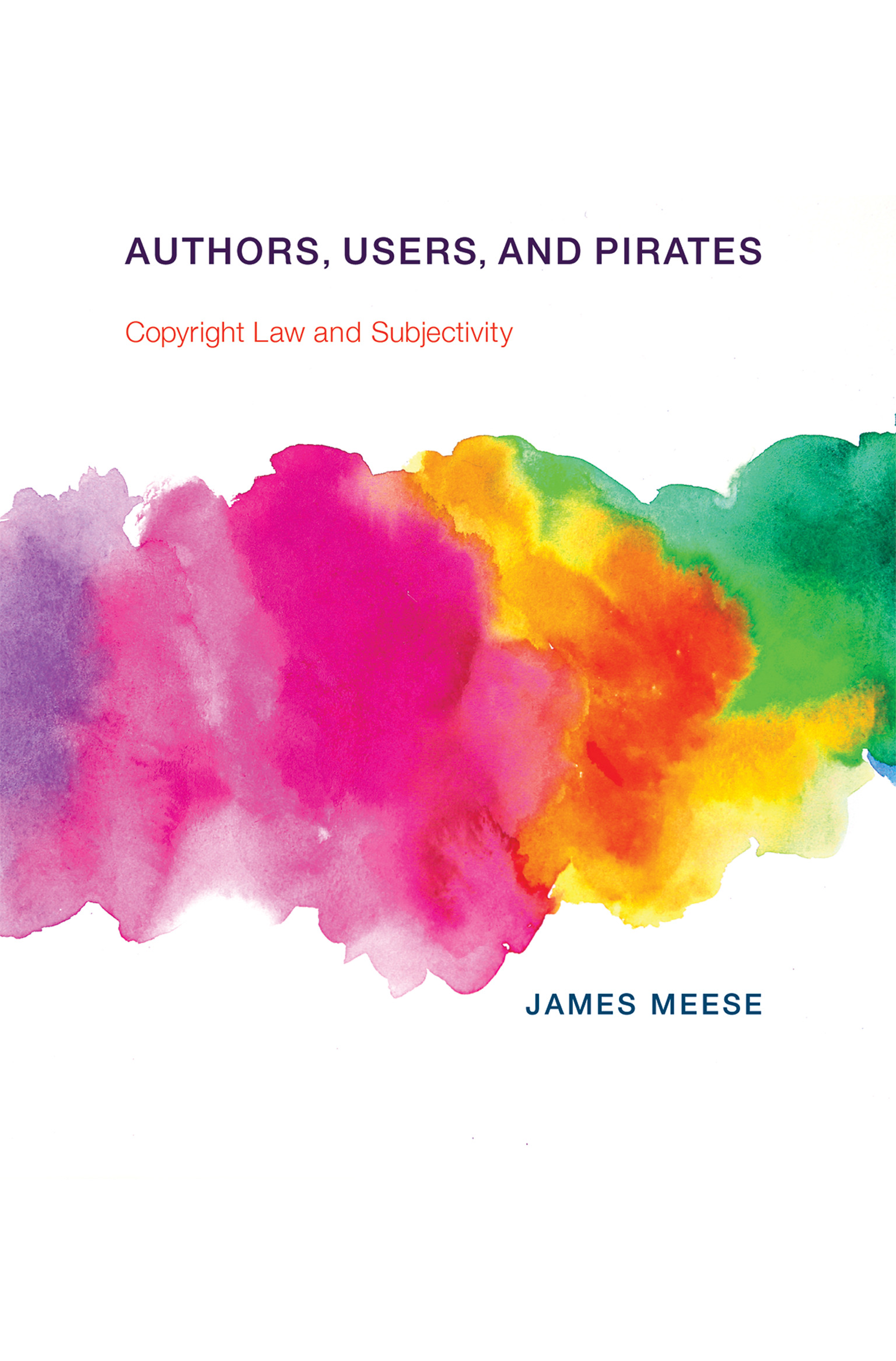
Authors, Users, and Pirates An examination of subjectivity in copyright law, analyzing authors, users, and pirates through a relational framework. In current debates over copyright law, the author, the user, and the pirate are almost always invoked. Some in the creative industries call for more legal protection for authors; activists and academics promote user rights and user-generated content; and online pirates openly challenge the strict enforcement of copyright law. In this book, James Meese offers a new way to think about these three central subjects of copyright law, proposing a relational framework that encompasses all three. Meese views authors, users, and pirates as interconnected subjects, analyzing them as a relational triad. He argues that addressing the relationships among the three subjects will shed light on how the key conceptual underpinnings of copyright law are justified in practice. Meese presents a series of historical and contemporary examples, from nineteenth-century cases of book abridgement to recent controversies over the reuse of Instagram photos. He not only considers the author, user, and pirate in terms of copyright law, but also explores the experiential element of subjectivity—how people understand and construct their own subjectivity in relation to these three subject positions. Meese maps the emergence of the author, user, and pirate over the first two centuries of copyright's existence; describes how regulation and technological limitations turned people from creators to consumers; considers relational authorship; explores practices in sampling, music licensing, and contemporary art; examines provisions in copyright law for user-generated content; and reimagines the pirate as an innovator. POLITICAL SCIENCE,Public Policy,Science & Technology Policy
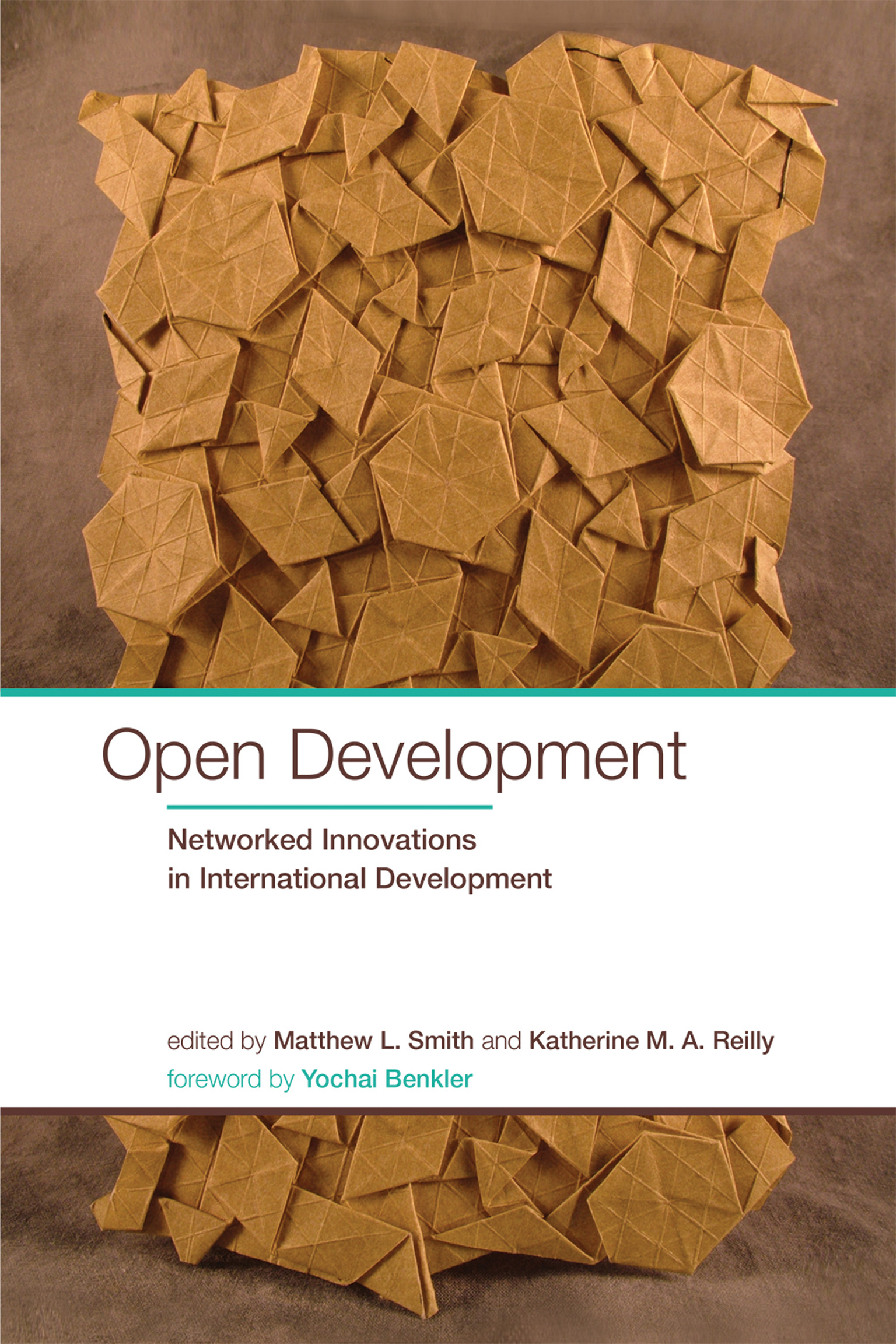
Open Development Experts explore current theory and practice in the application of digitally enabled open networked social models to international development. The emergence of open networked models made possible by digital technology has the potential to transform international development. Open network structures allow people to come together to share information, organize, and collaborate. Open development harnesses this power, to create new organizational forms and improve people's lives; it is not only an agenda for research and practice but also a statement about how to approach international development. In this volume, experts explore a variety of applications of openness, addressing challenges as well as opportunities. Open development requires new theoretical tools that focus on real world problems, consider a variety of solutions, and recognize the complexity of local contexts. After exploring the new theoretical terrain, the book describes a range of cases in which open models address such specific development issues as biotechnology research, improving education, and access to scholarly publications. Contributors then examine tensions between open models and existing structures, including struggles over privacy, intellectual property, and implementation. Finally, contributors offer broader conceptual perspectives, considering processes of social construction, knowledge management, and the role of individual intent in the development and outcomes of social models. Contributors Carla Bonina, Ineke Buskens, Leslie Chan, Abdallah Daar, Jeremy de Beer, Mark Graham, Eve Gray, Anita Gurumurthy, Havard Haarstad, Blane Harvey, Myra Khan, Melissa Loudon, Aaron K. Martin, Hassan Masum, Chidi Oguamanam, Katherine M. A. Reilly, Ulrike Rivett, Karl Schroeder, Parminder Jeet Singh, Matthew L. Smith, Marshall S. Smith Copublished with the International Development Research Centre of Canada (IDRC) POLITICAL SCIENCE,Public Policy,Science & Technology Policy
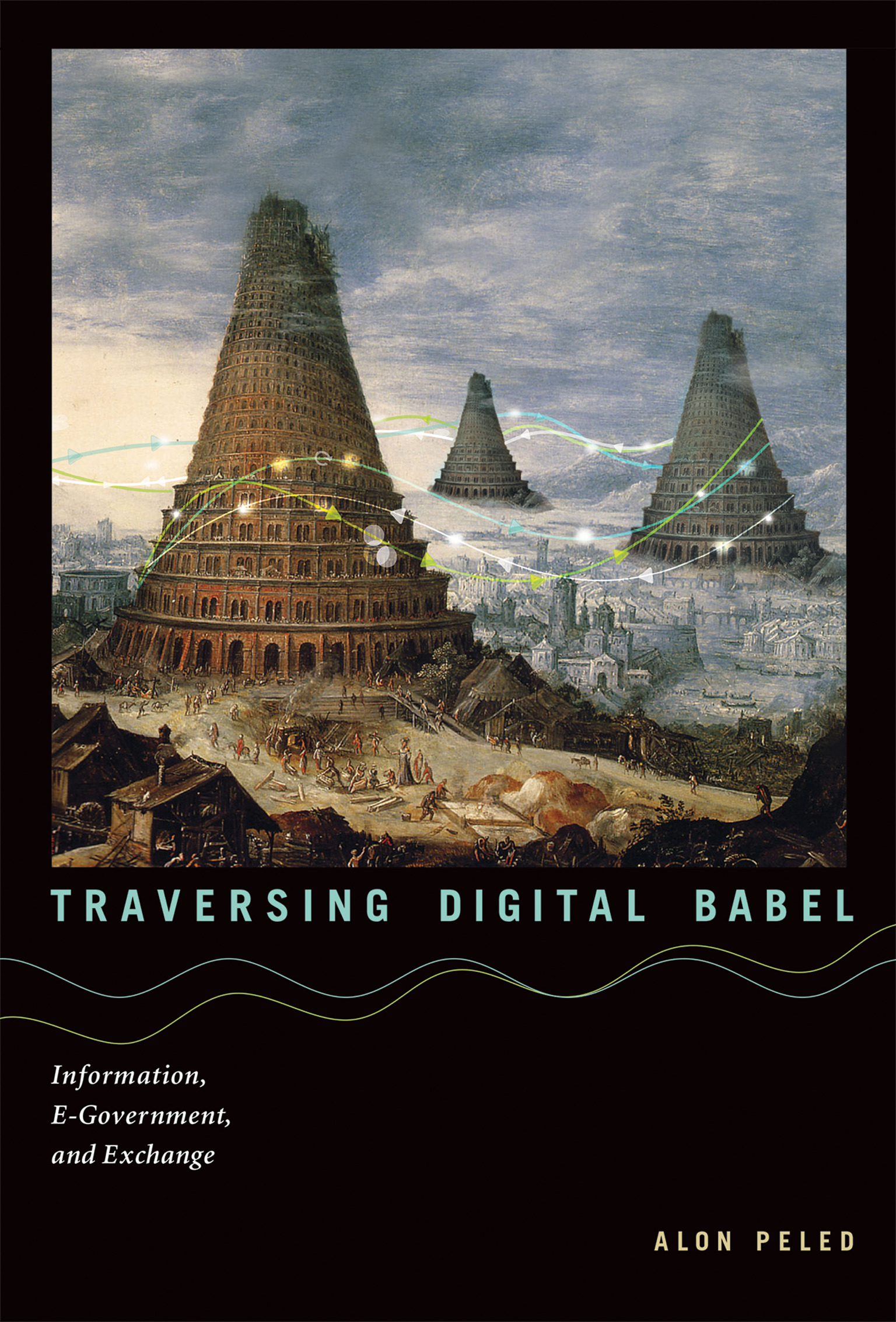
Traversing Digital Babel A groundbreaking approach to information sharing among government agencies: using selective incentives to “nudge” them to exchange information assets. The computer systems of government agencies are notoriously complex. New technologies are piled on older technologies, creating layers that call to mind an archaeological dig. Obsolete programming languages and closed mainframe designs offer barriers to integration with other agency systems. Worldwide, these unwieldy systems waste billions of dollars, keep citizens from receiving services, and even—as seen in interoperability failures on 9/11 and during Hurricane Katrina—cost lives. In this book, Alon Peled offers a groundbreaking approach for enabling information sharing among public sector agencies: using selective incentives to “nudge” agencies to exchange information assets. Peled proposes the establishment of a Public Sector Information Exchange (PSIE), through which agencies would trade information. After describing public sector information sharing failures and the advantages of incentivized sharing, Peled examines the U.S. Open Data program, and the gap between its rhetoric and results. He offers examples of creative public sector information sharing in the United States, Australia, Brazil, the Netherlands, and Iceland. Peled argues that information is a contested commodity, and draws lessons from the trade histories of other contested commodities—including cadavers for anatomical dissection in nineteenth-century Britain. He explains how agencies can exchange information as a contested commodity through a PSIE program tailored to an individual country's needs, and he describes the legal, economic, and technical foundations of such a program. Touching on issues from data ownership to freedom of information, Peled offers pragmatic advice to politicians, bureaucrats, technologists, and citizens for revitalizing critical information flows. POLITICAL SCIENCE,Public Policy,Science & Technology Policy

Protecting Children Online? A critical examination of efforts by social media companies—including Facebook, Twitter, Snapchat, and Instagram—to rein in cyberbullying by young users. High-profile cyberbullying cases often trigger exaggerated public concern about children's use of social media. Large companies like Facebook respond by pointing to their existing anti-bullying mechanisms or coordinate with nongovernmental organizations to organize anti-cyberbullying efforts. Do these attempts at self-regulation work? In this book, Tijana Milosevic examines the effectiveness of efforts by social media companies—including Facebook, Twitter, YouTube, Snapchat, and Instagram—to rein in cyberbullying by young users. Milosevic analyzes the anti-bullying policies of fourteen major social media companies, as recorded in companies' corporate documents, draws on interviews with company representatives and e-safety experts, and details the roles of nongovernmental organizations examining their ability to provide critical independent advice. She draws attention to lack of transparency in how companies handle bullying cases, emphasizing the need for a continuous independent evaluation of effectiveness of companies' mechanisms, especially from children's perspective. Milosevic argues that cyberbullying should be viewed in the context of children's rights and as part of the larger social problem of the culture of humiliation. Milosevic looks into five digital bullying cases related to suicides, examining the pressures on the social media companies involved, the nature of the public discussion, and subsequent government regulation that did not necessarily address the problem in a way that benefits children. She emphasizes the need not only for protection but also for participation and empowerment—for finding a way to protect the vulnerable while ensuring the child's right to participate in digital spaces. POLITICAL SCIENCE,Public Policy,Science & Technology Policy

Humanity Enhanced An argument that modern liberal democracies should tolerate human enhancement technologies, answering key objections by critics of these practices. Emerging biotechnologies that manipulate human genetic material have drawn a chorus of objections from politicians, pundits, and scholars. In Humanity Enhanced, Russell Blackford eschews the heated rhetoric that surrounds genetic enhancement technologies to examine them in the context of liberal thought, discussing the public policy issues they raise from legal and political perspectives. Some see the possibility of genetic choice as challenging the values of liberal democracy. Blackford argues that the challenge is not, as commonly supposed, the urgent need for a strict regulatory action. Rather, the challenge is that fear of these technologies has created an atmosphere in which liberal tolerance itself is threatened. Focusing on reproductive cloning, pre-implantation genetic diagnosis of embryos, and genetic engineering, Blackford takes on objections to enhancement technologies (raised by Jürgen Habermas and others) based on such concerns as individual autonomy and distributive justice. He argues that some enhancements would be genuinely beneficial, and that it would be justified in some circumstances even to exert pressure on parents to undertake genetic modification of embryos. Blackford argues against draconian suppression of human enhancement, although he acknowledges that some specific and limited regulation may be required in the future. More generally, he argues, liberal democracies would demonstrate liberal values by tolerating and accepting the emerging technologies of genetic choice. POLITICAL SCIENCE,Public Policy,Science & Technology Policy

Pirate Politics An examination of the Pirate political movement in Europe analyzes its advocacy for free expression and the preservation of the Internet as a commons. The Swedish Pirate Party emerged as a political force in 2006 when a group of software programmers and file-sharing geeks protested the police takedown of The Pirate Bay, a Swedish file-sharing search engine. The Swedish Pirate Party, and later the German Pirate Party, came to be identified with a “free culture” message that came into conflict with the European Union's legal system. In this book, Patrick Burkart examines the emergence of Pirate politics as an umbrella cyberlibertarian movement that views file sharing as a form of free expression and advocates for the preservation of the Internet as a commons. He links the Pirate movement to the Green movement, arguing that they share a moral consciousness and an explicit ecological agenda based on the notion of a commons, or public domain. The Pirate parties, like the Green Party, must weigh ideological purity against pragmatism as they move into practical national and regional politics. Burkart uses second-generation critical theory and new social movement theory as theoretical perspectives for his analysis of the democratic potential of Pirate politics. After setting the Pirate parties in conceptual and political contexts, Burkart examines European antipiracy initiatives, the influence of the Office of the U.S. Trade Representative, and the pressure exerted on European governance by American software and digital exporters. He argues that pirate politics can be seen as “cultural environmentalism,” a defense of Internet culture against both corporate and state colonization. POLITICAL SCIENCE,Public Policy,Science & Technology Policy
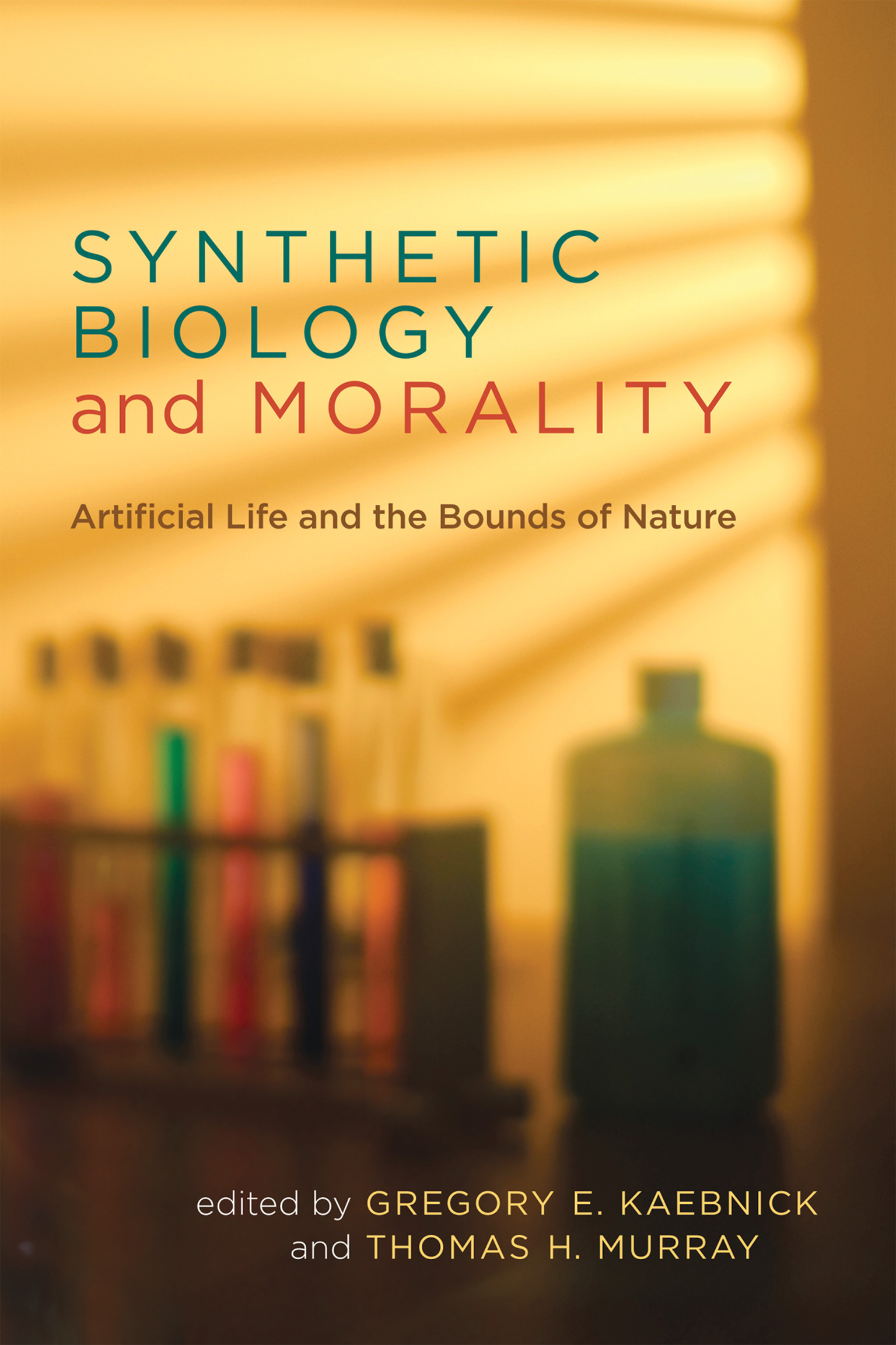
Synthetic Biology and Morality A range of views on the morality of synthetic biology and its place in public policy and political discourse. Synthetic biology, which aims to design and build organisms that serve human needs, has potential applications that range from producing biofuels to programming human behavior. The emergence of this new form of biotechnology, however, raises a variety of ethical questions—first and foremost, whether synthetic biology is intrinsically troubling in moral terms. Is it an egregious example of scientists “playing God”? Synthetic Biology and Morality takes on this threshold ethical question, as well as others that follow, offering a range of philosophical and political perspectives on the power of synthetic biology. The contributors consider the basic question of the ethics of making new organisms, with essays that lay out the conceptual terrain and offer opposing views of the intrinsic moral concerns; discuss the possibility that synthetic organisms are inherently valuable; and address whether, and how, moral objections to synthetic biology could be relevant to policy making and political discourse. Variations of these questions have been raised before, in debates over other biotechnologies, but, as this book shows, they take on novel and illuminating form when considered in the context of synthetic biology. Contributors John Basl, Mark A. Bedau, Joachim Boldt, John H. Evans, Bruce Jennings, Gregory E. Kaebnick, Ben Larson, Andrew Lustig, Jon Mandle, Thomas H. Murray, Christopher J. Preston, Ronald Sandler POLITICAL SCIENCE,Public Policy,Science & Technology Policy

Penal Populism Expertly drawing on international examples and existing literature, Penal Populism closes a gap in the field of criminology. In this fascinating expose of current crime policy John Pratt examines the role played by penal populism on trends in contemporary penal policy. Penal populism is associated with the public's decline of deference to the criminal justice establishment amidst alarm that crime is out of control. Pratt argues that new media technology is helping to spread national insecurities and politicians are not only encouraging such sentiments but are also being led on by them. Pratt explains it is having most influence in the development of policy on sex offenders, youth crime, persistent criminals and anti-social behaviour. This topical resource also covers new dimensions of the phenomenon, including: the changing nature and structure of the mass media less reliance on the more orthodox expertise of civil servants and academics limitations to the impact of populism, bureaucratic resistance from judges, lawyers and academics and the restorative justice movement. This is essential reading for students, researchers and professionals working in criminology and crime policy. POLITICAL SCIENCE,Public Policy,Social Policy
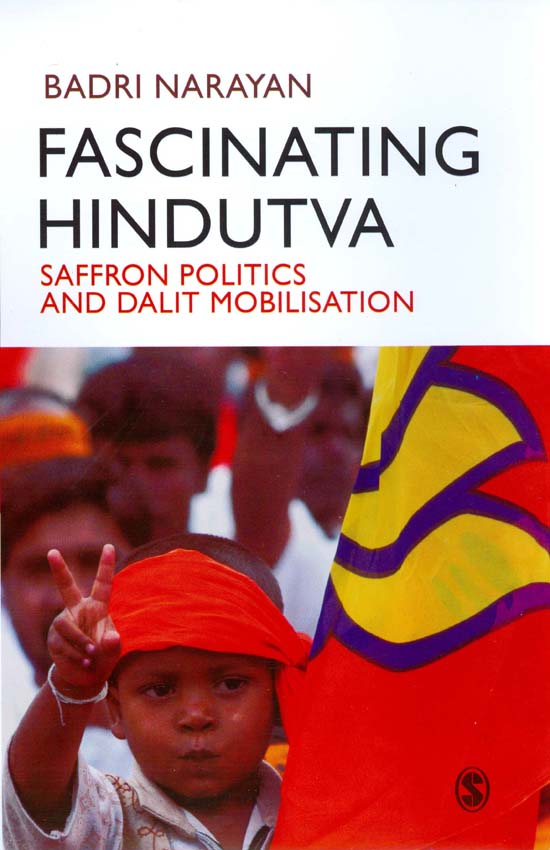
Fascinating Hindutva Fascinating Hindutva examines how, aided by other Hindutva forces like RSS and VHP, the strategies of BJP for mobilizing dalits rests on reinterpreting their Hindu past and unifying them under the metanarrative of Hindutva. It is an exploration of the fascinating tactics used by the Hindutva forces to politically mobilize individual dalit castes like the Nishads, Musahars and Dusadhs by saffronising their heroes. POLITICAL SCIENCE,Public Policy,Social Policy
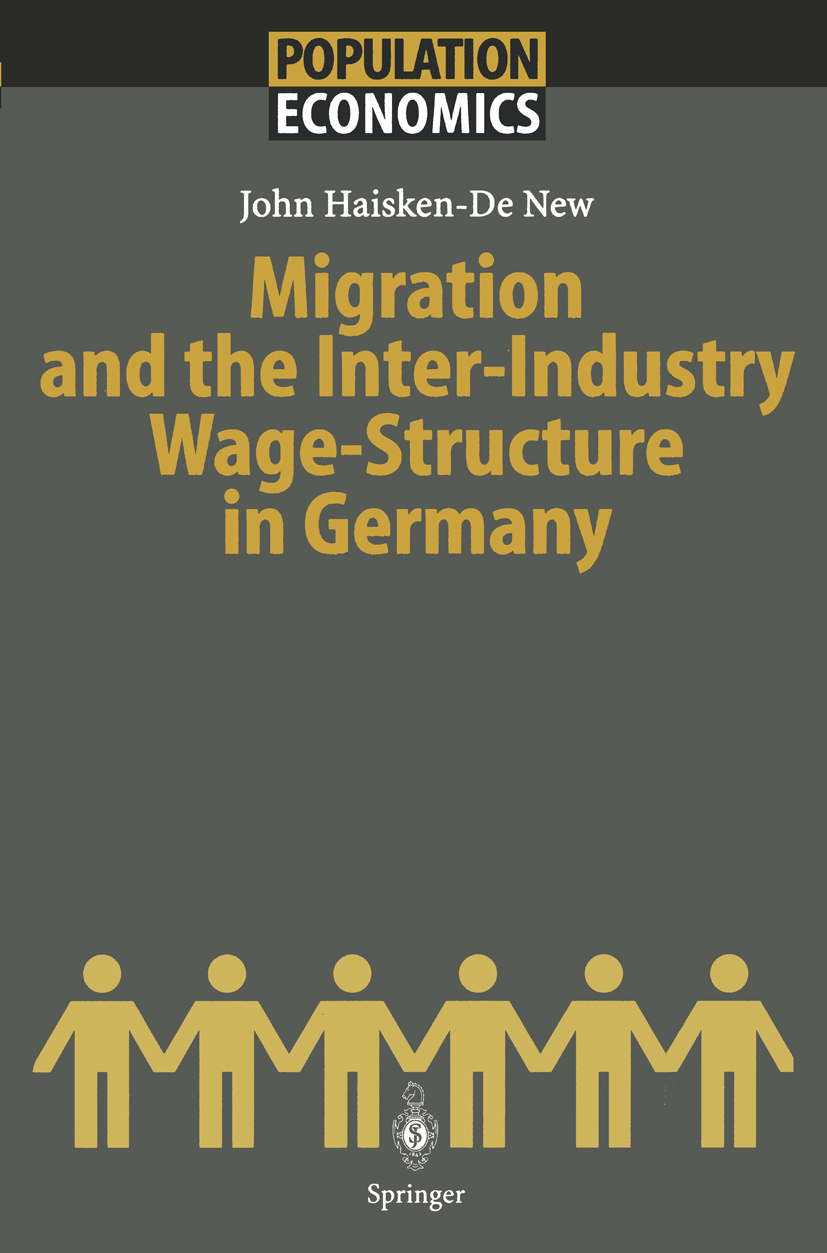
Migration and the Inter-Industry Wage Structure in Germany Although the issue of migration has received substantial attention in public debate in most countries of the West, only moderately satisfactory attention has been given in the economic literature. This book analyses the case of Germany from an economic point of view. It examines questions such as: Are there substantial negative side-effects of migration, faced by native workers, as sometimes publicly claimed? Do highly skilled and unskilled natives experience different effects? Do certain foreigner national groups affect natives differently? How important is the level of education of these incoming foreigners in determining wage impacts on natives? Do native workers in some industries profit from migration, while others suffer? How is the industrial wage structure affected by migration, if at all? POLITICAL SCIENCE,Public Policy,Social Policy
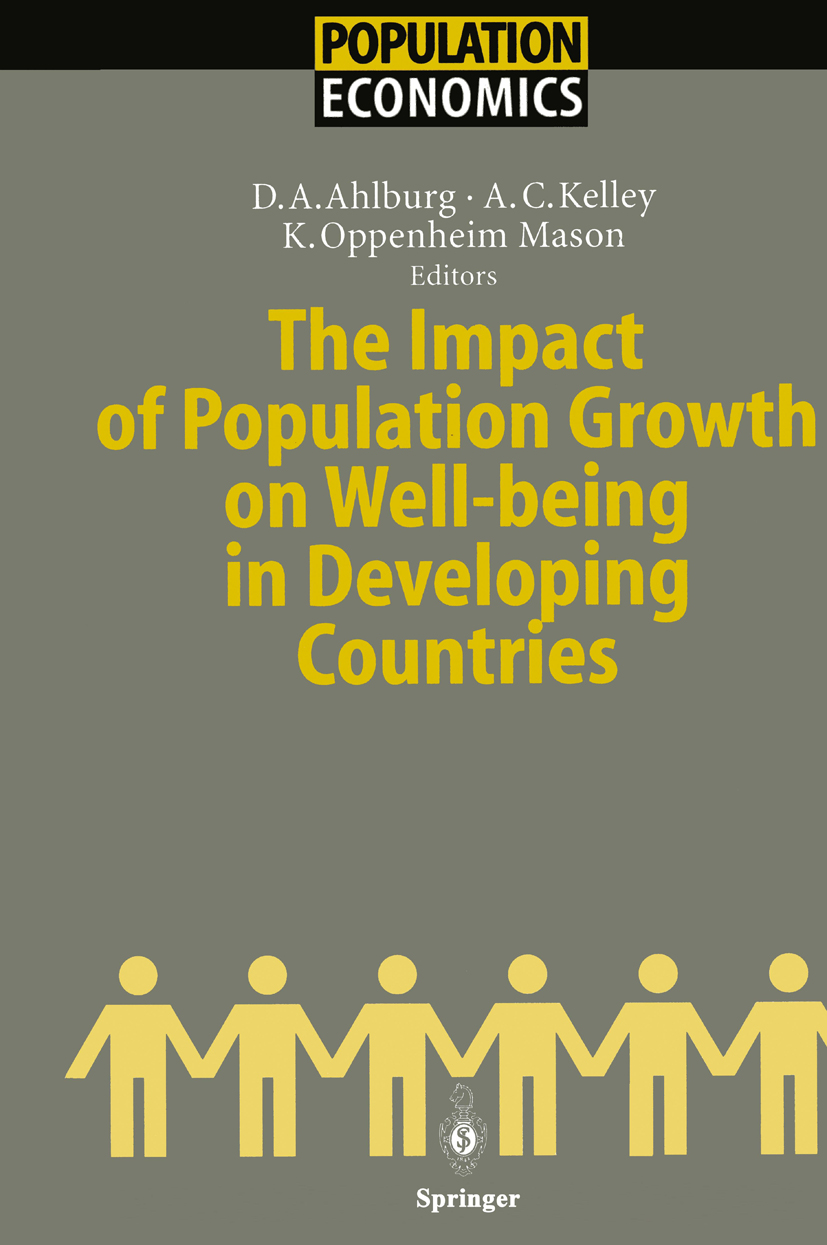
The Impact of Population Growth on Well-being in Developing Countries This book examines the nature and significance of the impact of population growth on the weIl-being of developing countries-in particular, the effects on economic growth, education, health, food supply, housing, poverty, and the environment. In addition, because family planning programmes often significantly affect population growth, the study examines the impacts of family planning on fertility and health, and the human rights implications of family planning programmes. In considering the book's conclusions about the impact of population growth on development, four caveats should be noted. First, the effects of population growth vary from place to place and over time. Thus, blanket statements about overall effects often cannot be made. Where possible, the authors note the contexts in which population effects are strongest and weakest. Second, all of the outcomes examined in this book are influenced by factors other than population growth. Moreover, the impact of population growth may itself vary according to the presence or absence of other factors. This again makes bl anket statements about the effects of population growth difficult. Throughout the chapters, the authors try to identify other relevant factors that influence the outcomes we discuss or that influence the impact of population growth on those outcomes. POLITICAL SCIENCE,Public Policy,Social Policy

Fighting Europe’s Unemployment in the 1990s Following the five books listed above on an earlier page, the Egon Sohmen-Foundation herewith submits its sixth volume. Once again, it is a collection of academic papers that were discussed at a symposium sponsored by the Foundation and subsequently revised. Readers not familiar with the Foundation may be interested to know that it was established in 1987 by Helmut Sohmen of Hong Kong in memory of his late brother, Egon Sohmen (1930-1977). Egon Soh men was an international economist highly respected in North America and in Europe, notably for his work on flexible exchange rates and on the economics of allocation and competition. Born in Linz (Austria) and educated as an economist in Vienna, Tiibingen, and Cambridge, Mass., Egon Sohmen held teaching posts in several places (M.I.T., Yale, Frankfurt, Saarbriicken, Minnesota, and Heidelberg). As an active participant in numerous international con ferences and workshops, he truly belonged to the international research community of his time and age cohort. His lasting reputation greatly helped me to convene the active participants of this symposium. POLITICAL SCIENCE,Public Policy,Social Policy
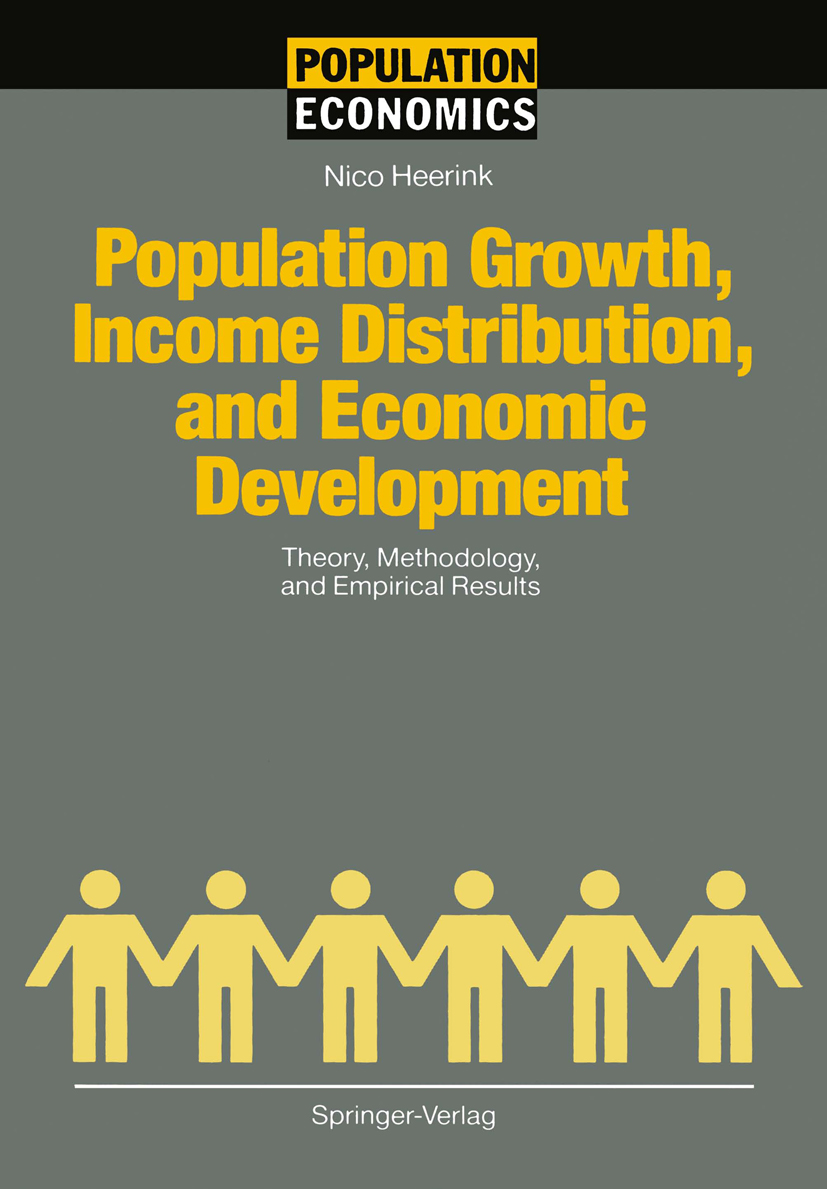
Population Growth, Income Distribution, and Economic Development In this book, a model of long-term interrelationshipsbetween income distribution, population growth and economicdevelopment is developed and estimated from data for 54countries. The results indicate that a reduction of incomeinequality leads to lower fertility and mortality, toimprovedbasic needs satisfaction, and to lower labour forceparticipation of young and old males and of females in Asiaand Africa. The effect of income distribution on saving andconsumption is found to be negligible. These outcomessuggest that family planning and health policies in LDCswill show better results when they are supplemented withpolicies aimed at makingthe poor benefit from economicgrowth. As regards development policy, the results indicatethat a reduction of income inequality does not impair theformation of physical capital, but enhances the formation ofhuman capital and lowers the growth rate of the labourforce. POLITICAL SCIENCE,Public Policy,Social Policy
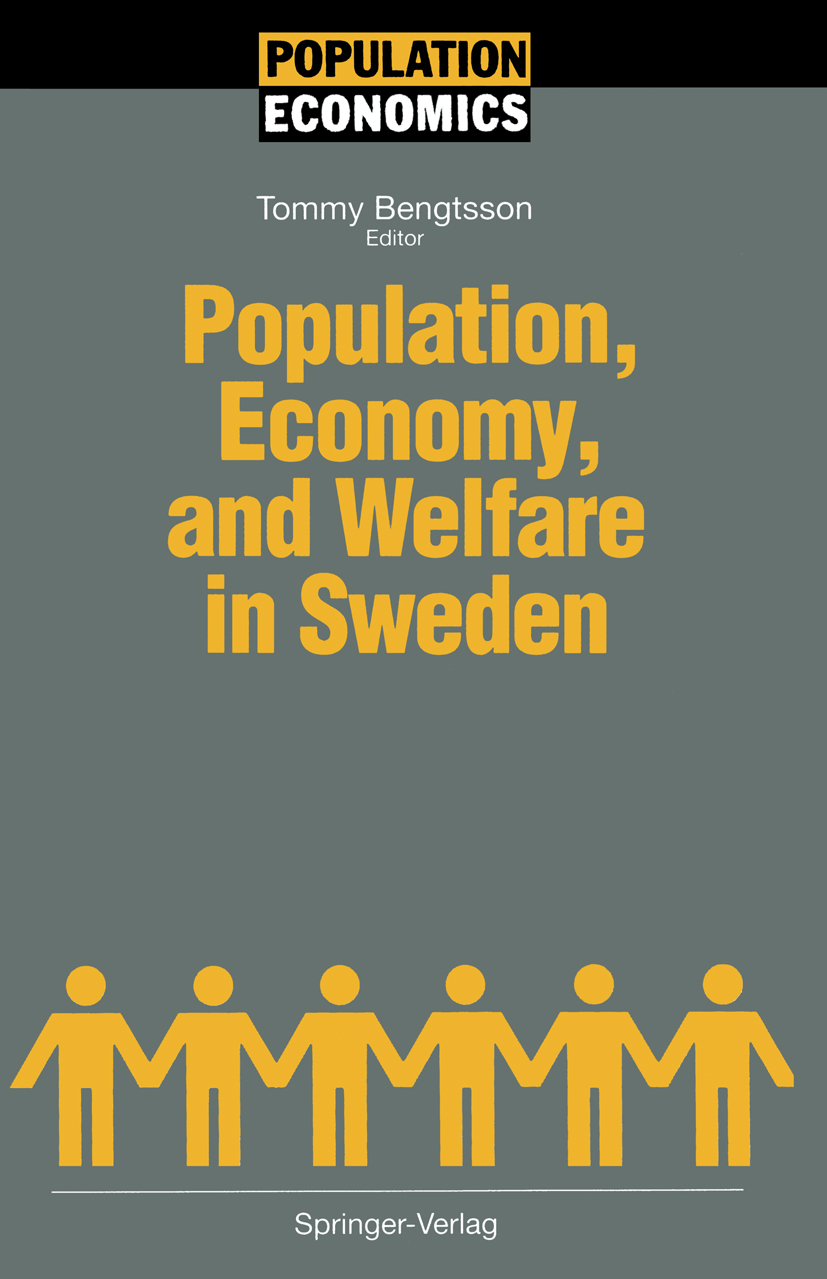
Population, Economy, and Welfare in Sweden Tommy Bengtsson The Swedish welfare model of the 1960s and 1970s excited great interest among many other countries. Today it still is an ideal image for some but a warning for many others. The reason why opinion about the Swedish welfare model has changed is primarily Sweden's financial problems, which are associated with a badly financed and excessively large public sector. It is argued that the size of the budget deficit is a great problem in itself, but also, and perhaps more importantly, that the large public sector has negative effects on the entire economy since it lead to inefficient allocation of resources. A first step in order to solve these problems is to examine how they arose. The questions then are to what extent the large public sector which Sweden has today results from social entitlements which have come into existence since the 1960s, from the maturing of welfare systems decided upon earlier, from unfavourable demographic developments, or from economic stagnation, and how these factors are interlinked. What is quite clear is that Sweden has had very low economic growth during the 1970s and 1980s compared with the preceding period. But so have many other industrial countries, without their having in consequence found themselves in diffi culties as great as Sweden's. Therefore economic stagnation alone cannot explain Sweden's situation. POLITICAL SCIENCE,Public Policy,Social Policy
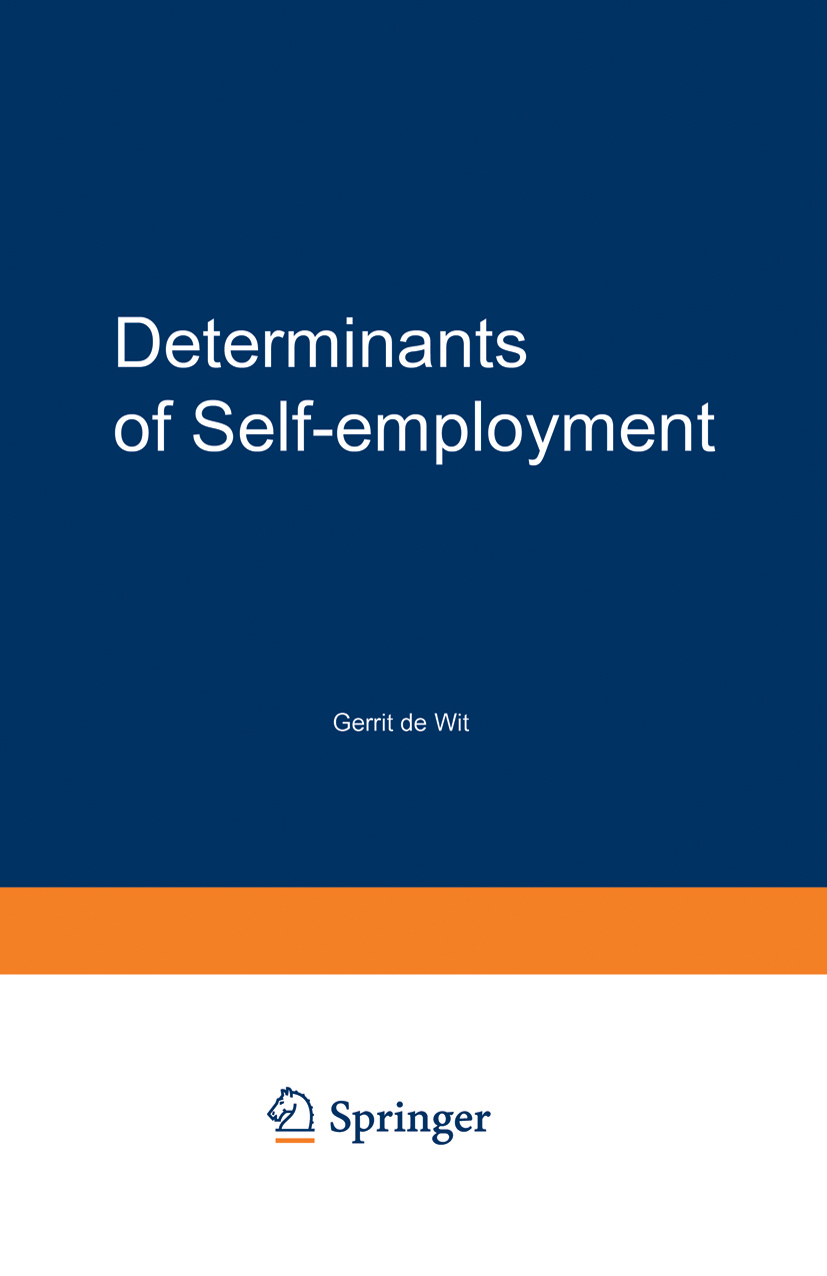
Determinants of Self-employment This book is the result of five years of research that I carried out as a research fellow at the Faculty of Economics and Econometrics of the University of Amsterdam. The project was initiated in 1986 by Frans van Winden and Roy Thurik. Frans van Winden became interested in self employment through his work concerning government behavior. In the models that he employs, the government is influenced by various social groups, the political strength of which is related to their size. As one of these is the group of self-employed individuals, he became interested in determinants of the size of this group. Roy Thurik was professionally interested in the subject because of his work at the Research Institute for Small and Medium-sized Business in the Netherlands (EIM), an institute that does much research in this area. Together, they wrote a proposal for a research project, for which they received funding from the Dutch Ministry of Economic Affairs . These funds were supplemented by the University of Amsterdam and at a later stage by the Organization for the Advancement of Research in the Economic Discipline (ECOZOEK), that is part of the Netherlands Organization for Scientific Research (NWO). This support is gratefully acknowiedged. The commercial edition of this book was partIy financed by the Centre for Energy Conservation and Environmental Technology (CE), the Center for Research in Experimental Economics and Political Decisionmaking (CREED), and the University of Amsterdam. POLITICAL SCIENCE,Public Policy,Social Policy

An Econometric Analysis of Individual Unemployment Duration in West Germany In contemporary labor economics increasing attention is paidto the fact that unemployment is not only a stock but also aflow phenomenon. The present micro-econometric studyanalyses the impact of important socio-economiccharacteristics on unemployment duration in West Germany.Based on a search theoretic framework unemployment durationis considered as a stochastic process whose evolution isinfluenced by economicand demographic variables likeunemployment benefits, expected wage offers, training andage. This is modeled by application of the concept of thehazard rate which denotes the conditional exit rate fromunemployment over time given elapsed unemployment duration.Contrasting more traditional models a semi-parametricapproachis chosen which reduces the danger ofmis-specification of the stochastic duration process. Thisprocedure also is particularly suitable for the analysis ofgrouped observations on unemployment duration typicallygenerated by longitudinal data sets as the German"Socio-Economic Panel" which is utilized for this study.Besides deriving a set of empirical results on unemploymentduration in West Germanymethodological issues of durationanalysis are considered with particular attention paid tothe impact of the sample design. Also, important outcomesfrom search theory and findings from other hazard rateanalysesare surveyed. POLITICAL SCIENCE,Public Policy,Social Policy
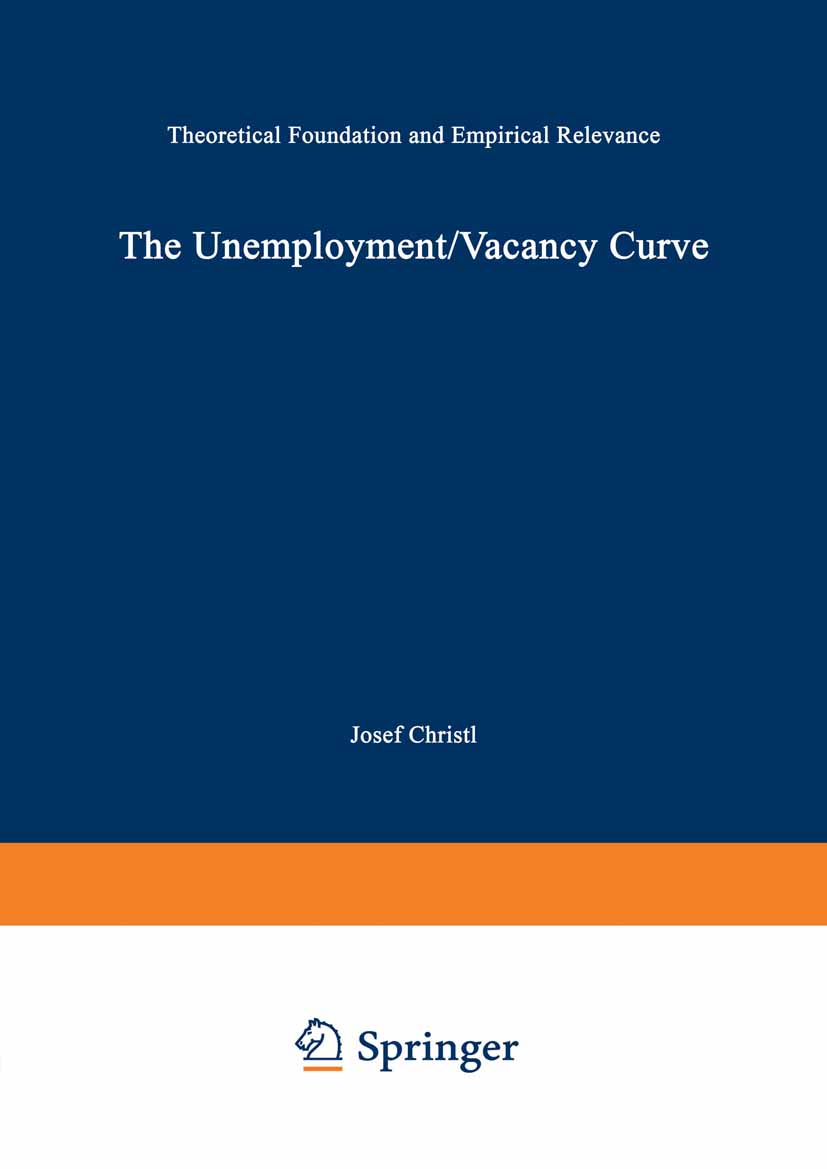
The Unemployment/Vacancy Curve Rising unemployment has become one of the most challenging problems for economic policy in many developed economies over the last fifteen years. In the second half of the 1970s and during the first half of the 1980s the labour market situation worsened dramatically. For the OECD area as a whole, unemployment as a percentage of the civilian labour force went up from 3.3 percent in 1974 to 8.1 percent in 1985. The increase in unemployment rates was even more pronounced for OECD-Europe, where it climbed from 3.3 percent to 10.5 percent in this period. Table 1.1: Unemployment Rates in some aECD Countries, 1974-1989 yearly average 1989 1974{79 1974 1979 1985 1980/85 1985/89 USA 5,6 5,8 7,2 5,2 6,8 8,1 6,2 UK 2,2 4,5 11,6 6,5 4,2 10,0 9,7 3,3 8,3 7,3 3,5 6,6 7,9 FRG 2,1 2,4 1,3 1,5 2,4 2,2 Sweden 1,6 1,7 Austria 1,1 1,7 3,6 3,4 1,5 3,0 3,5 Austria*) 1,5 2,0 4,8 5,0 1,9 3,6 5,3 OECDEurope 3,3 5,7 10,5 9,0 4,8 9,1 10,0 OECD 3,7 5,2 8,1 6,6 5,0 7,7 7,5 *) national definition - see footnote 1). Source: OECD, 1989; BMSA. POLITICAL SCIENCE,Public Policy,Social Policy

Structural Unemployment High and persistent unemployment rates in Europe during the eighties gave rise to a lively discussion about the nature and causes of joblessness. Among other sources structural unemployment was blamed for the lack of response of unemployment to increasing aggregate demand. Renewed attention was thus devoted to an analysis of the magnitude and the development of structural unemployment as well to its possi ble determinants. In this literature, the Beveridge curve experienced a resurrection and, at first glance, it seemed to be an appropriate tool to analyse the aforementioned issues. However, it was soon recognized that the Beveridge curve, i. e. the relation between unemployment and vacancies, was anything but stable, thus requiring a care ful distinction between dynamic loops around a (stable?) long-run Beveridge curve and possible shifts due to, say, an increasing mismatch between labor supplied and demanded. The controversy is far from being settled at the time of this writing. This book contains a collection of hitherto unpublished papers which are devoted to a theoretical and econometric analysis of structural unemployment. The papers put considerable emphasis on the question to what extent the Beveridge curve can serve as an adequate tool for such studies. The countries under consideration are Germany and Austria. In what follows a very brief summary of each paper will be outlined. Franz and Siebeck present, at some length, a theoretical and econometric analysis of the Beveridge curve in Germany. POLITICAL SCIENCE,Public Policy,Social Policy
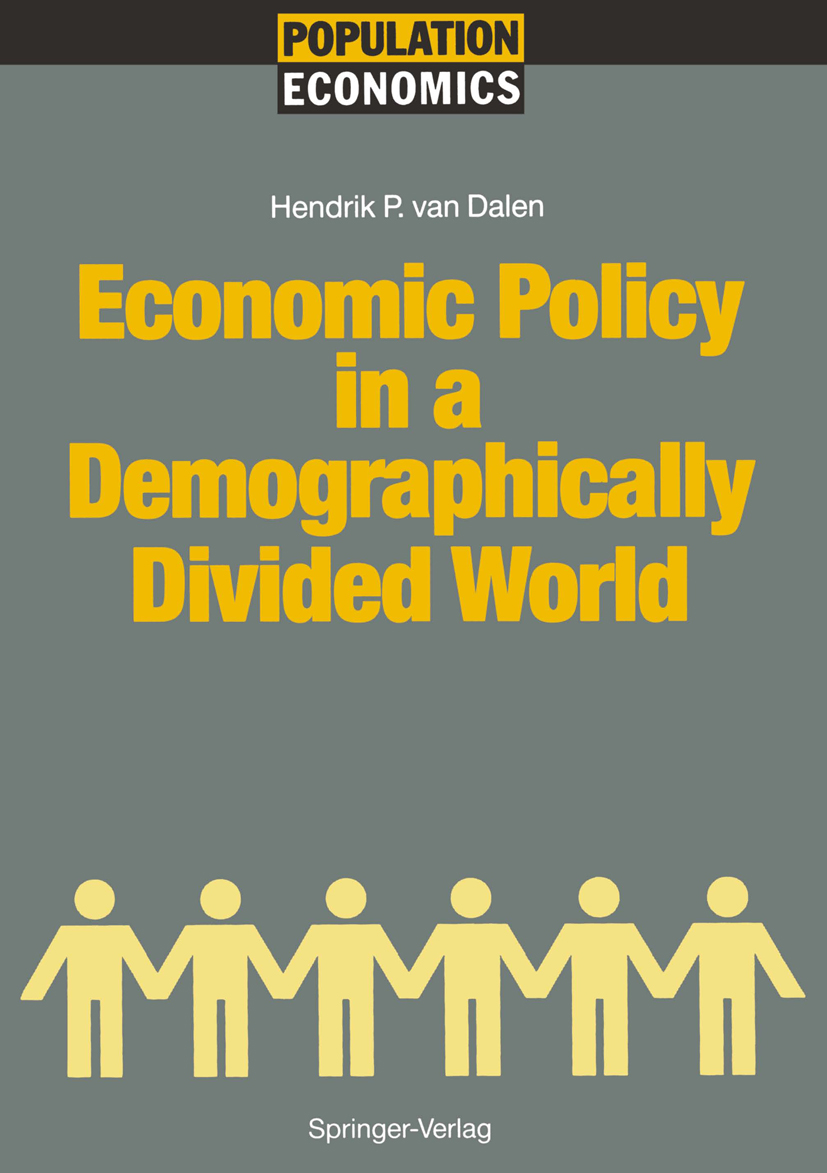
Economic Policy in a Demographically Divided World Economic Policy in a Demographically Divided World containsthe economic analysis of the consequences of demographicchange and the diverging population developments in aninterdependent world economy in particular. The globaldivergence in demographic developments gives rise to amyriadof economic and ethical problems. This topic istreated with the help of themathematical apparatus ofneoclassical optimal growth models. The author tries todisentangle the basic policy issues of a demographicallydivided world, such as a selective immigration policy,sustainable patterns of international lending and borrowing,development aid, and dynamic optimal taxation.The most important feature of the book is that it bringstogether information and theories of fairly recent date toanalyse a practical policy problem, viz. issues related to aworld economy that is characterised by a demographicdivision. This stylised fact is hardly given some attentionin current economic theory and the book contains withrespect to this stylised fact some new results.Customers might benefit from the book by gaining intuitionconcerning principles of economic policy in a worldcharacterised by demographic change. POLITICAL SCIENCE,Public Policy,Social Policy
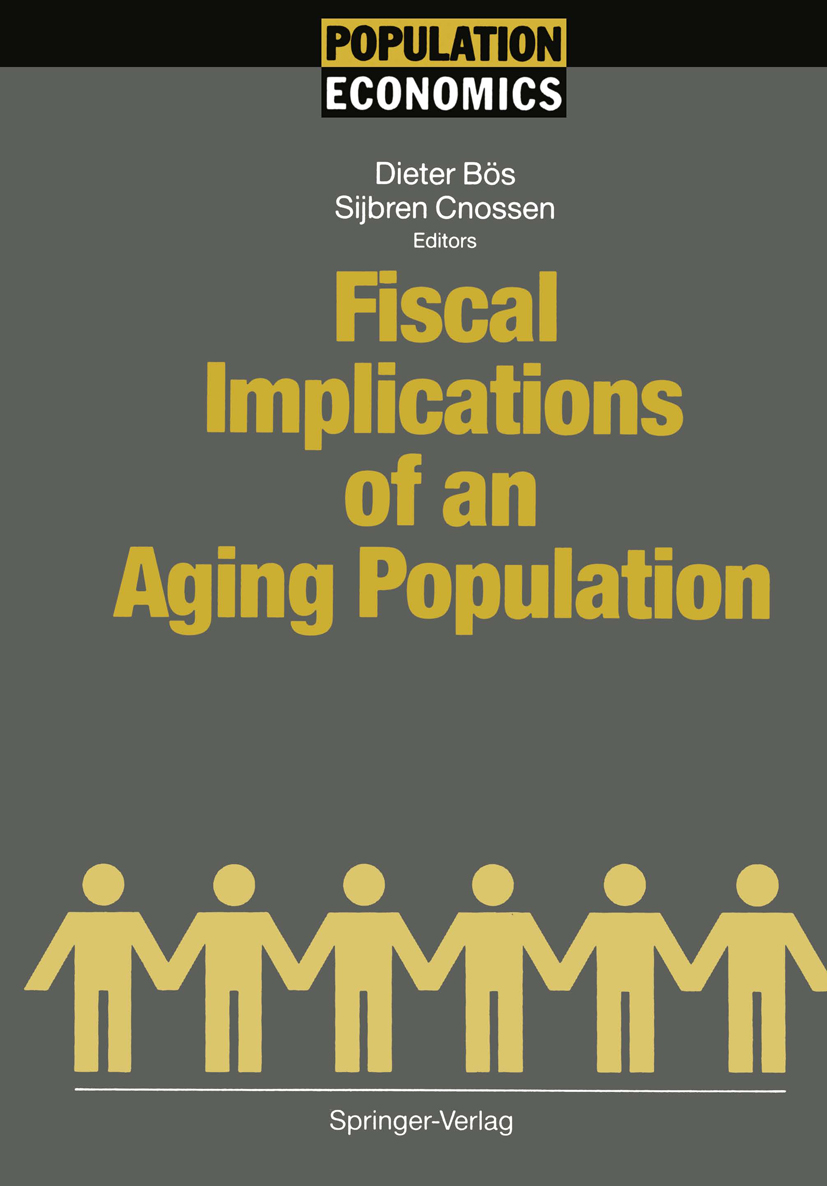
Fiscal Implications of an Aging Population Serious research into the causes and implications of anaging population is a relatively recent phenomenon. Thoughseveral relevant issues of aging havereceived considerableattention in public and political discussions (especially inEuropean countries and in Japan), the economics professionis somewhat lacking behind. This is particularly true forthetheoretical underpinnings of the economics of populationaging. Until now, the aging-debate is primarily led byinstitutionalists. The present book with its analytical andeconometric studies on fiscal implications of populationaging is an important step in the process of theoreticalanalysis of aging. It is of interest both for populationeconomists (and demographers) and for public economists -providing a bridge between these areas of research. POLITICAL SCIENCE,Public Policy,Social Policy

Intrafamily Bargaining and Household Decisions A model of household decisions based on a bargainingapproach is developed providing a comprehensive frameworkfor the analysis of family behavior. Treating the family asan economic organization, household behavior is explained bythe cooperation of utility maximizing individuals. Thedifference to traditional microeconomic household models isthat theassumption of a joint household utility functionis abandoned. Instead of this, a game theoretic approach isused to model family decisions as a result of intrafamilybargaining. Considering the development of the spouses`human capital in a dynamic approach, the long-term effectsof intrafamily specialization in market work and work athome are analyzed. Onemajor finding is that in a dynamicsetting non-Pareto efficient allocations may result.Empirical tests demonstrate the relevanace of the bargainingapproach. POLITICAL SCIENCE,Public Policy,Social Policy
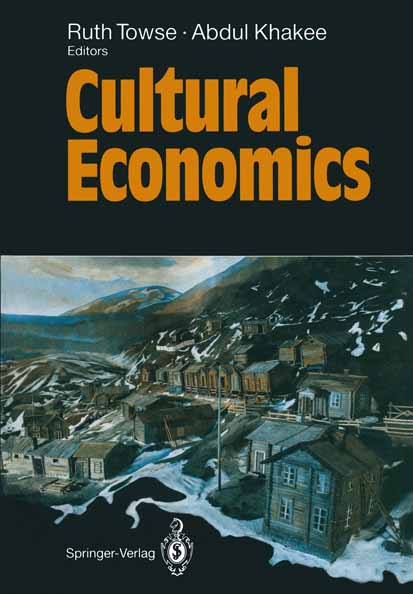
Cultural Economics With contributions by numerous experts POLITICAL SCIENCE,Public Policy,Social Policy
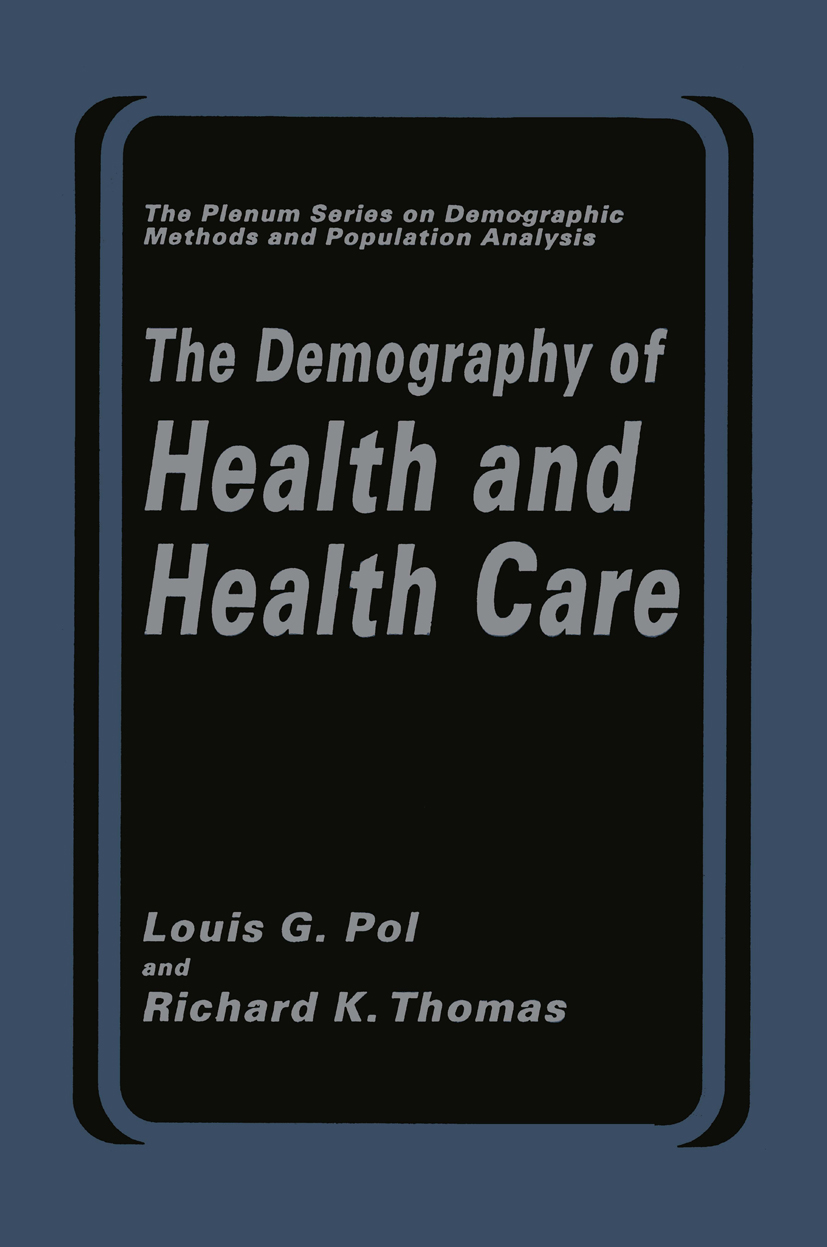
The Demography of Health and Health Care The 1980s witnessed the emergence of an applied subdiscipline within de mography that is coming to be termed health demography. As yet there is no distinct body of research formally categorized under this heading, nor are there professionals who bear the title of health demographer. In fact, most of those involved with health demography are not demographers but sociologists, economists, epidemiologists, and others who are applying concepts and tech niques from demography to concrete problems in the delivery of health care. Nevertheless, the vague boundaries of this subdiscipline are becoming in creasingly visible, and the 1990s promise to be the era of health demography. Many factors have contributed to the emergence of this new field. The transition the health care industry underwent during the 1980s served to modify dramatically the mindset of those in health care from one based on a philanthropic orientation to a highly competitive business orientation. Al most overnight the industry became market driven and consumer oriented, resulting in an explosion in the demand for both demographic data and health statistics. The need to integrate and interpret data from these two fields has provided a major impetus for the development of health demography. At the same time, the redefining of health and illness along lines more in keeping with a social than a clinical perspective, and the reconceptualization of etiology within a lifestyles framework, have further emphasized the need for health demography. POLITICAL SCIENCE,Public Policy,Social Policy
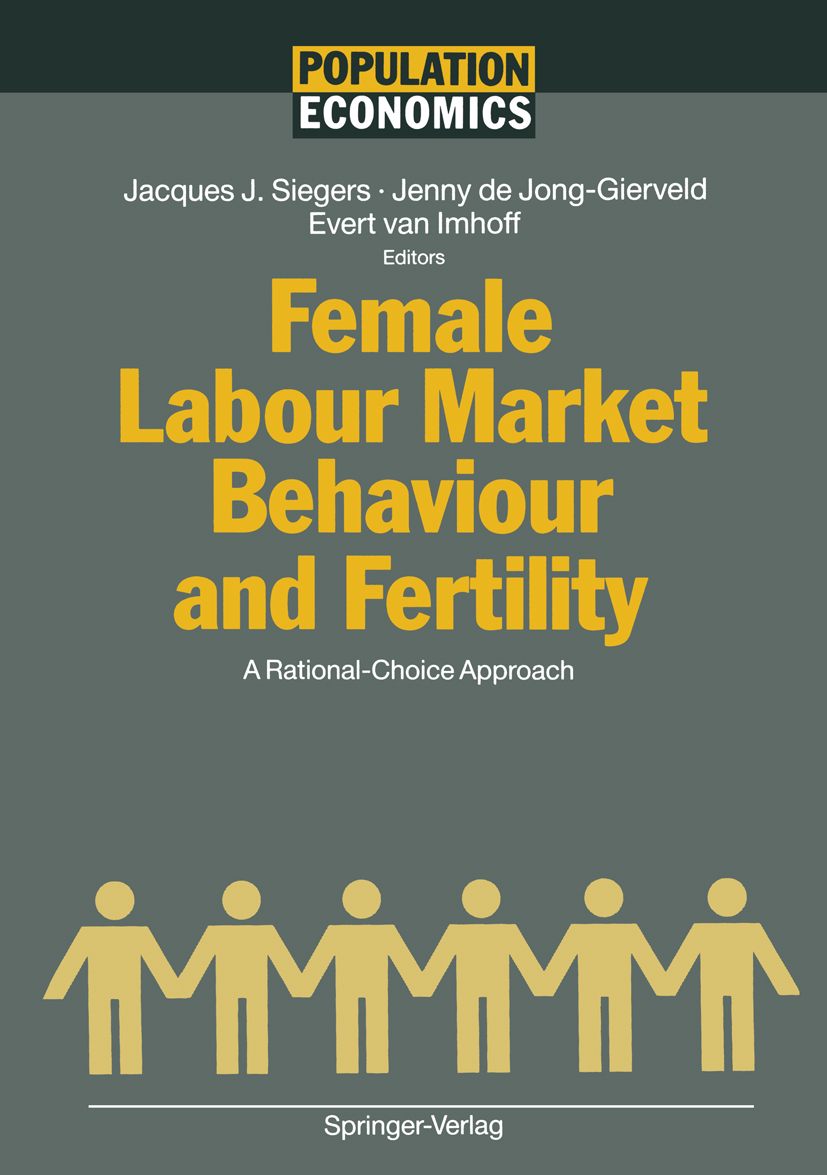
Female Labour Market Behaviour and Fertility Proc.of a Workshop Organized by the Netherlands Interdisci- plinary Demographic Institute (NIDI) in Collaboration with the Economic Institute/Centre for Interdisciplinary Research on Labour Market and Distribution Issues (CIAV) of UtrechtUniversity Held in the Hague, The Netherlands,Apr.20-22,1989 POLITICAL SCIENCE,Public Policy,Social Policy
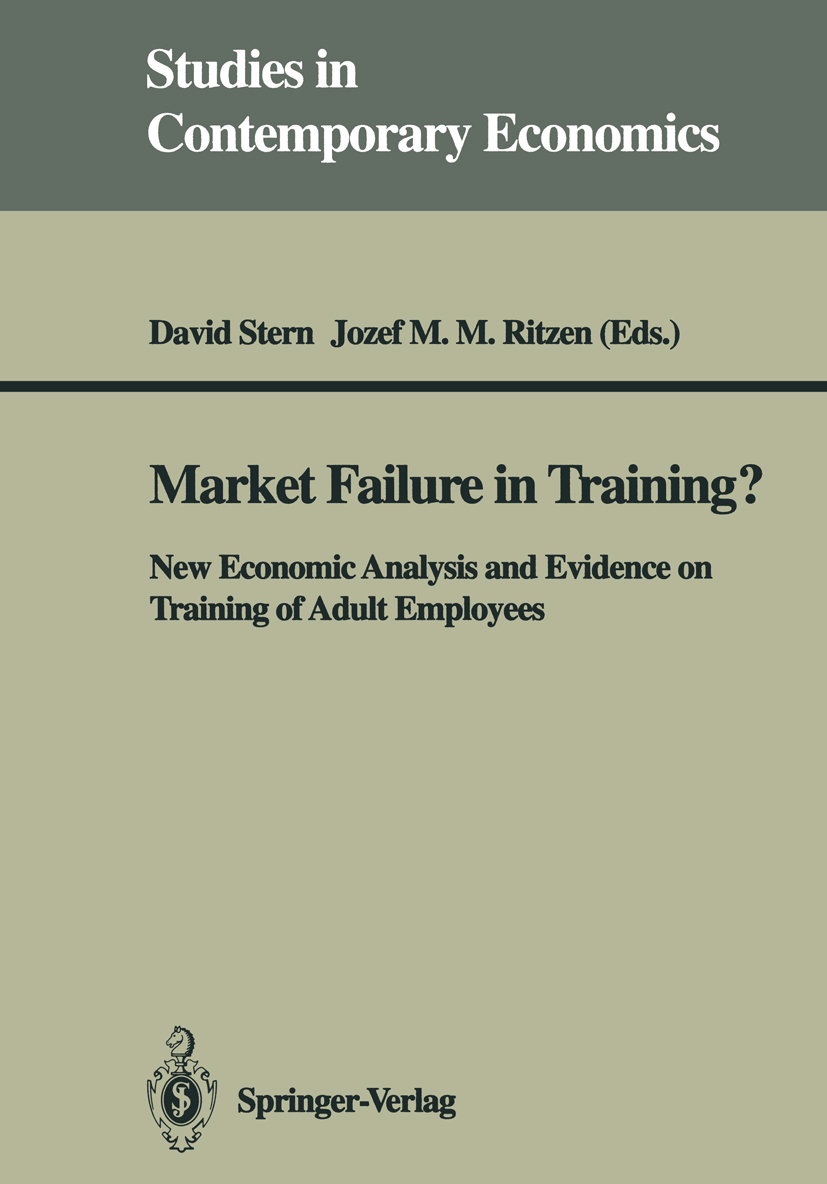
Market Failure in Training? The papers in this volume were fIrst presented at a symposium on "An Expanded Public Role in Job Training? The Issue of Market Failure in the Provision of Training. " The symposium took place in May, 1989. It was sponsored by the LaFollette Institute of Public Affairs at the University of Wisconsin, Madison. JozefRitzen, then in Madison on leave from Erasmus University in the Netherlands, organized the symposium. Subsequently he became Minister of Education and Science for the Netherlands. He asked David Stern to fInish the work of editing the papers for publication. All the papers have been revised in light of comments by discussants at the symposium, as well as subsequent comments by the editors and outside reviewers. INTRODucrroN AND OVERVIEW Jozef M. M. Ritzen Erasmus University Rotterdam Minister of Education and Science The Netherlands David Stem School of Education University of California, Berkeley Two factors are contributing to an increased interest in the training of adult employees. First, there is the present high rate of change in the technologies embodied in products and in production processes. This enhances the negative effect of the undersupply of training on economic growth. Higher levels of training would provide a more fertile environment for technological change. The second factor is the aging of the population. POLITICAL SCIENCE,Public Policy,Social Policy
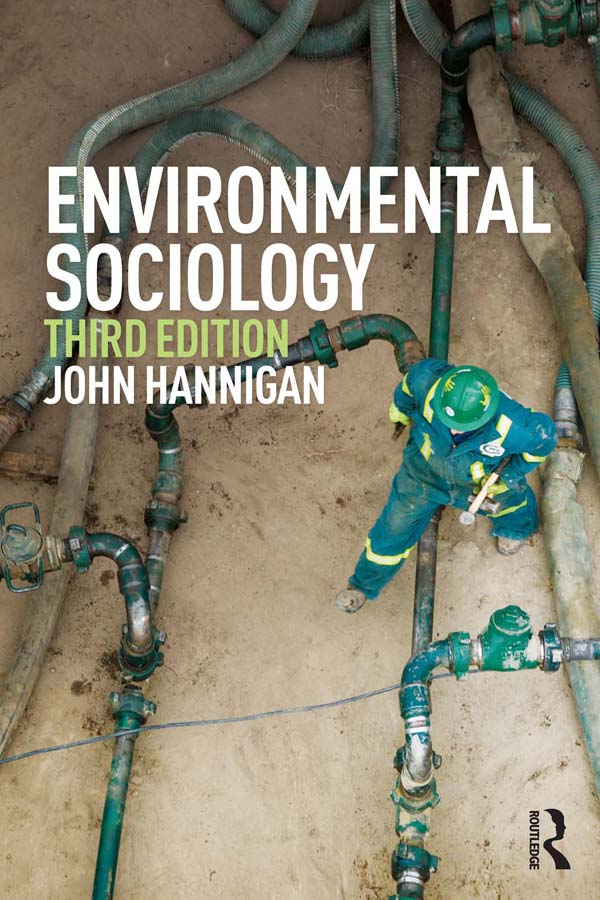
Environmental Sociology The third edition of John Hannigan’s classic undergraduate text has been fully updated and revised to highlight contemporary trends and controversies within global environmental sociology. Environmental Sociology offers a distinctive, balanced treatment of environmental issues, reconciling Hannigan’s much-cited model of the social construction of environmental problems and controversies with an environmental justice perspective that stresses inequality and toxic threats to local communities. POLITICAL SCIENCE,Public Policy,Social Policy

Being a Refugee This is a longitudinal study of highly qualified professionals, before and after they arrive as refugees in the UK. It powerfully challenges the stereotyped images of refugees, showing how and what they learn as they build viable and respected identities for themselves in a new social and cultural space. POLITICAL SCIENCE,Public Policy,Social Policy

Maternity Services and Policy in an International Context This book is the first comprehensive international overview of maternity services. Drawing on concepts of risk and social citizenship, it explores the relationship between welfare regimes and health policy by comparing and contrasting provision for childbearing women. Each substantive chapter focuses on a different country, presenting detailed contextual information on health care provision, maternity interventions and birth outcomes there. They discuss key issues such as birth rates and fertility patterns, the role of patient choice, attitudes to place of birth and maternity entitlements among others, and the countries covered represent diverse welfare regimes, including Ireland, Scotland, Sweden, the Netherlands, Germany, Italy, Japan, the United States, Canada, Australia and New Zealand. An extended introduction and a conclusion draw the book together and place it in the context of the literature on comparative welfare regimes. It is an important reference for students and academics interested in comparative social policy, health services research, and maternity services and policies. POLITICAL SCIENCE,Public Policy,Social Policy
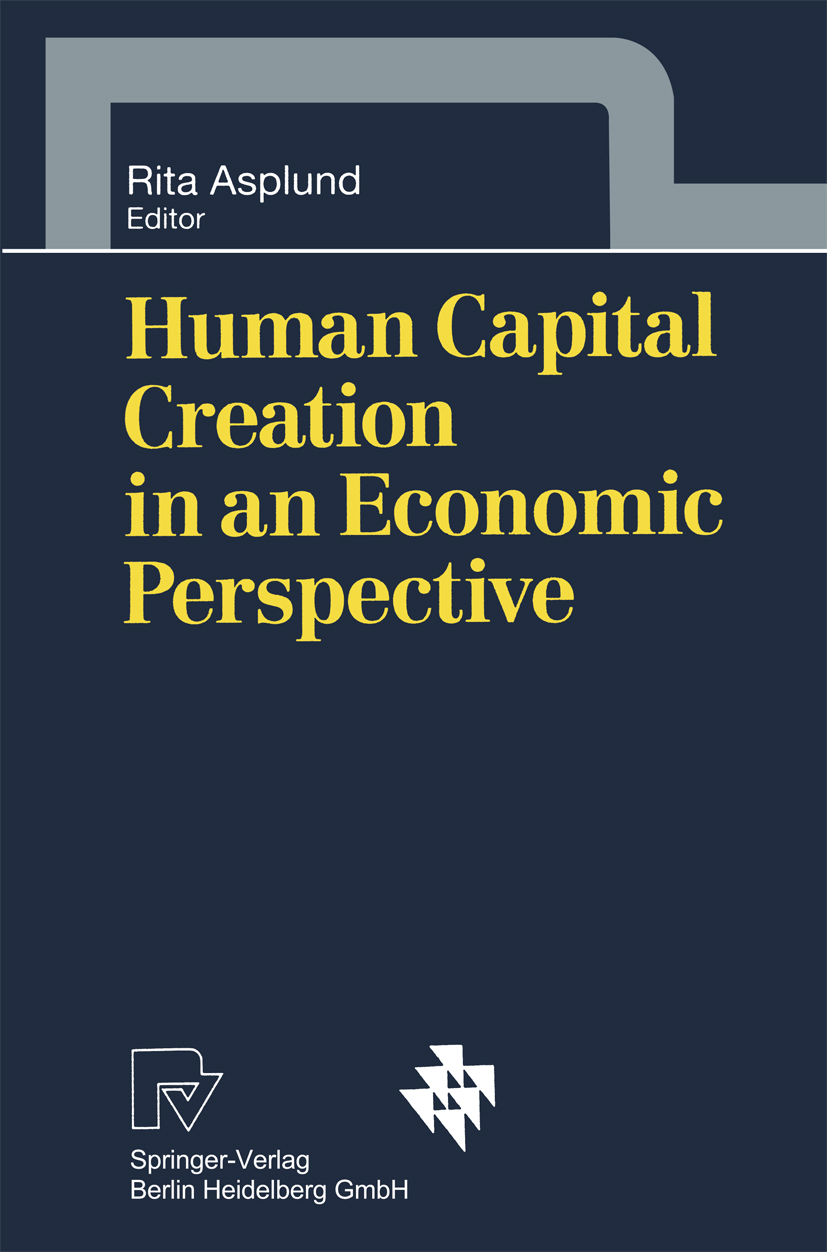
Human Capital Creation in an Economic Perspective The past few decades have seen a revolutionary increase in interest in the economic role of education and training at the societal, business, and individual levels. This is mainly due to the strong post-war growth in industrialized economies, which has been driven by rapid technological progress and far-reaching structural change and, in the end, has resulted in increasingly skill-intensive production and growing demandfor more educated labour. Today it is frequently argued that with the increasing importance of the role of know-how, the workforce has become the most important single input in the production process. Simultaneously the dramatic increase in the availability of large micro-Ievel databases has opened enormous possibilities to study the economic role of human capital creation also empirically. The economic perspective of human capital accumulation is, however, of utmost importance also in times of deep economic recession. Periods of economic slowdown and rapidly increasing unemployment tend to in crease the demandfor advanced education and training in particular. This brings up, in turn, questions regarding overeducation and satisfying both private and social retums on investments in human capital. POLITICAL SCIENCE,Public Policy,Social Policy

Population — Development — Environment Because the number of options is often limited, small island states tend to find it uncommonly difficult to strike a balance between population, envi ronment, and development. Relatively high population density and small land areas, without much in the way of natural resources, do not provide the best of circumstances for improving the living conditions of the popu lation, especially a fast-growing one. The result is often stunted economic development and environmental stress both on land and offshore. The developments in the island state of Mauritius over the past 30 years, however, can serve as an inspiration and illustration of how extremely ad verse conditions can be overcome. In the early 1960s Mauritius was trying to cope with rapid population growth, extreme poverty, and grim economic 2 prospects. Population density was 324 inhabitants per km , total fertility was 5.7, and GNP per capita was less than $200. In 1990 the situation in Mauritius was radically different. Although 2 population density had increased to 527 inhabitants per km , total fertility had dropped to 2.0, and GNP per capita had increased to $2,310. Economic stagnation had been replaced by steady growth and full employment, and environmental problems were being addressed as issues of high priority. POLITICAL SCIENCE,Public Policy,Social Policy

International Migration Under Incomplete Information It is the main purpose of the book to give a logically consistent foundation of migration decision making under incomplete information in a unified framework. Decision rules for migration are derived from a general model of Stochastic Dynamic Programming and the properties of temporary migration equilibria are discussed as well. Finally, some hints are given for esti- mating the theoretical models which are elaborated in the book. Many results concerning the properties of optimal migration policies and of temporary migration equilibria are new. For example, it is demonstrated that less information about a country might it make more attractive for immigration, and conditions are analyzed that imply the existence of a significant stream of migrants even between identical countries in a temporary equilibrium state. The book is written for the mathematically oriented reader in economics, operations research or econometrics who is interested in application of Stochastic Dynamic Programming to an important field of research in population economics. POLITICAL SCIENCE,Public Policy,Social Policy
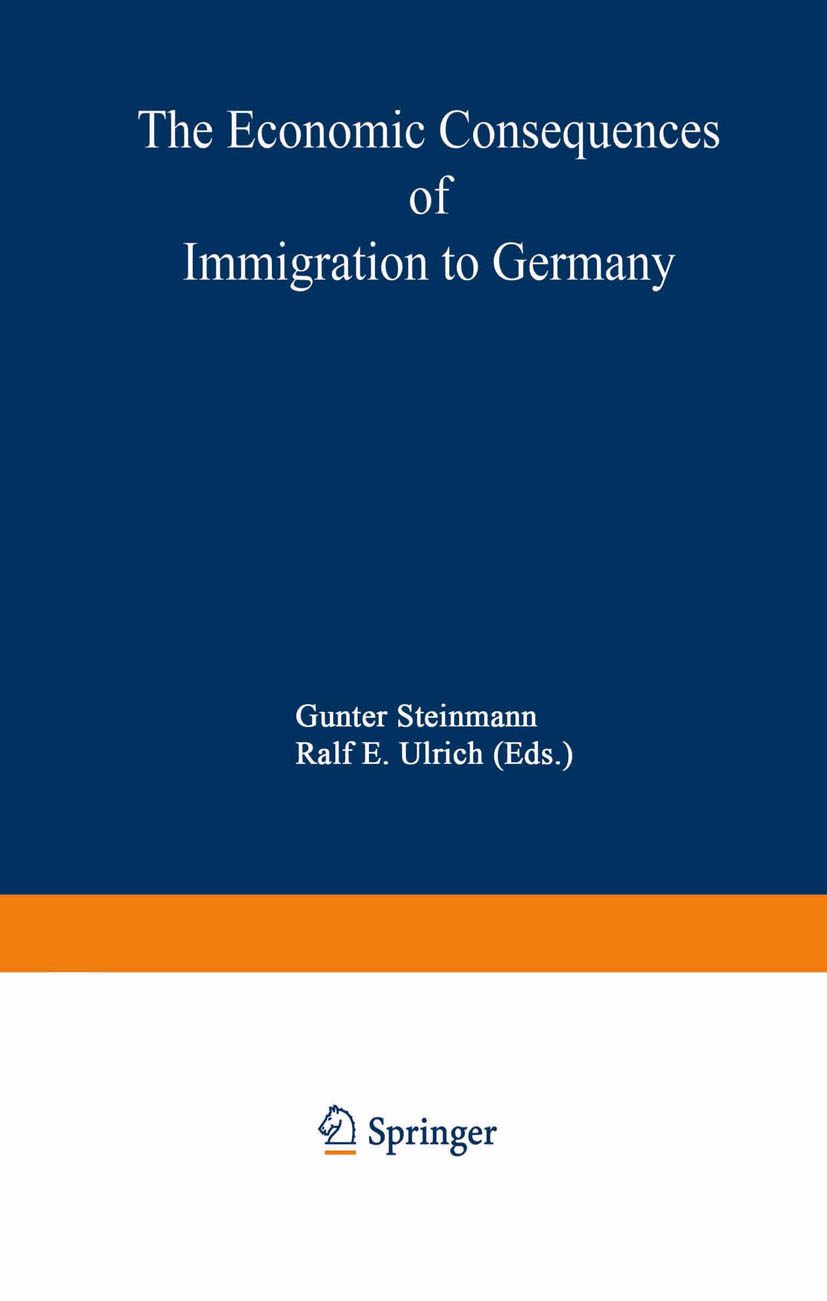
The Economic Consequences of Immigration to Germany This volume discusses some economic aspects of immigration with special refer ence to the case of Germany. Immigration has become a major issue in Germany. Germany still does not have an official immigration policy in spite of the fact that more than 8 percent of the residents are non-citizens and that Germany · s immigration figures almost have reached the US figures. The foreign Iabor supply strongly influences the German Iabor market. The bulk of foreign workers is employed in certain industries. In some industries (mining, steel) 20 and more percent of the employees are foreign workers. Most foreign workers are blue collar workers with low wages. The Iabor demand for immigrants has declined in the last 15 years while the foreign population and Iabor supply has increased. As a consequence, foreigners experience higher unemployment rates than Germans. The fall of the Berlin wall and the collapse of the communist regimes in East Europe further increased the blue collar Iabor supply and strengthened the competition for foreign workers on the German Iabor market. POLITICAL SCIENCE,Public Policy,Social Policy
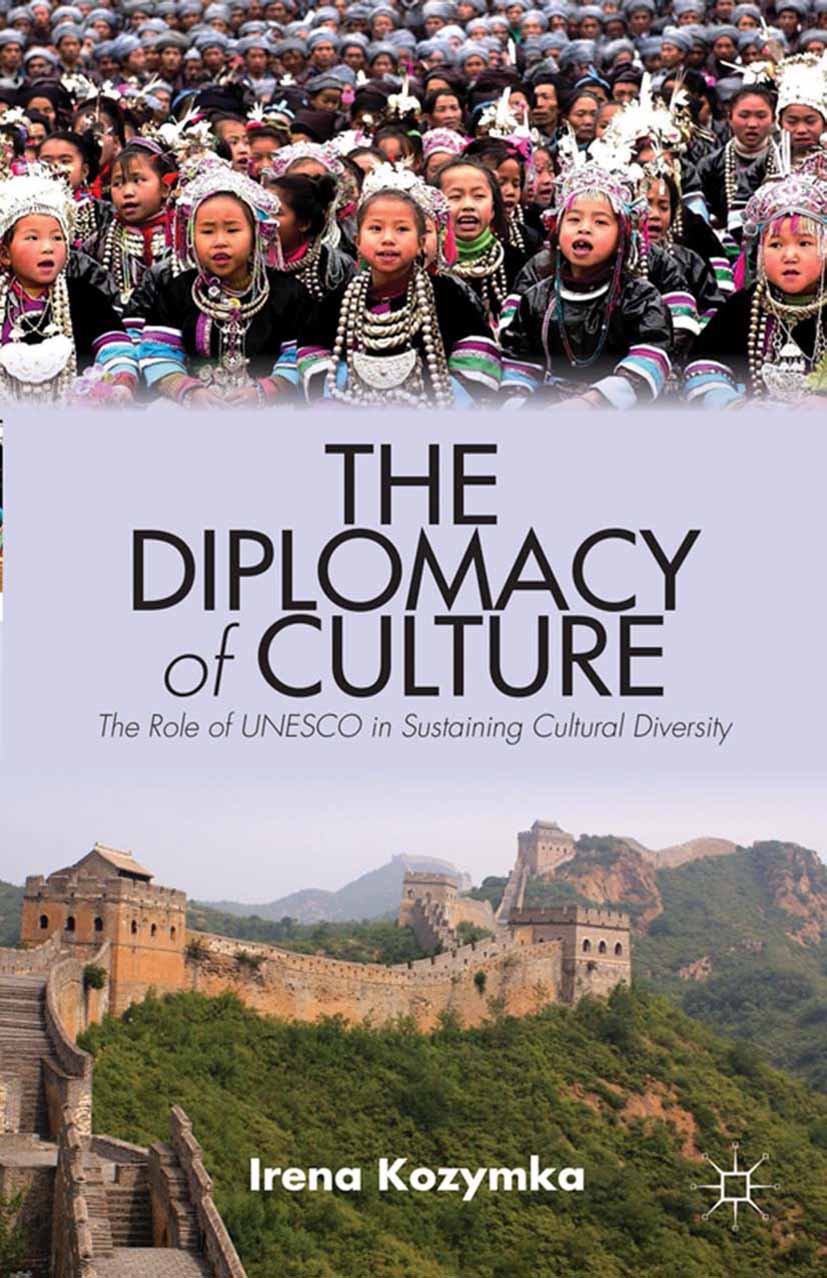
The Diplomacy of Culture Cultural diversity, because it is perceived to have significant security, developmental, and social implications, is fast becoming one of the major political issues of the day. At the international level, it overlaps with the now extensive debates on multiculturalism within states. This work shows how cultural diversity challenges the understanding of international relations as relations between states and, by looking at the issue through the magnifying glass of an international organization, offers innovative insights into the interplay between various levels of international society. The book examines in particular the role of UNESCO, the only United Nations agency responsible for culture and the main forum for international diplomacy on the issue of cultural diversity. POLITICAL SCIENCE,Public Policy,Social Policy
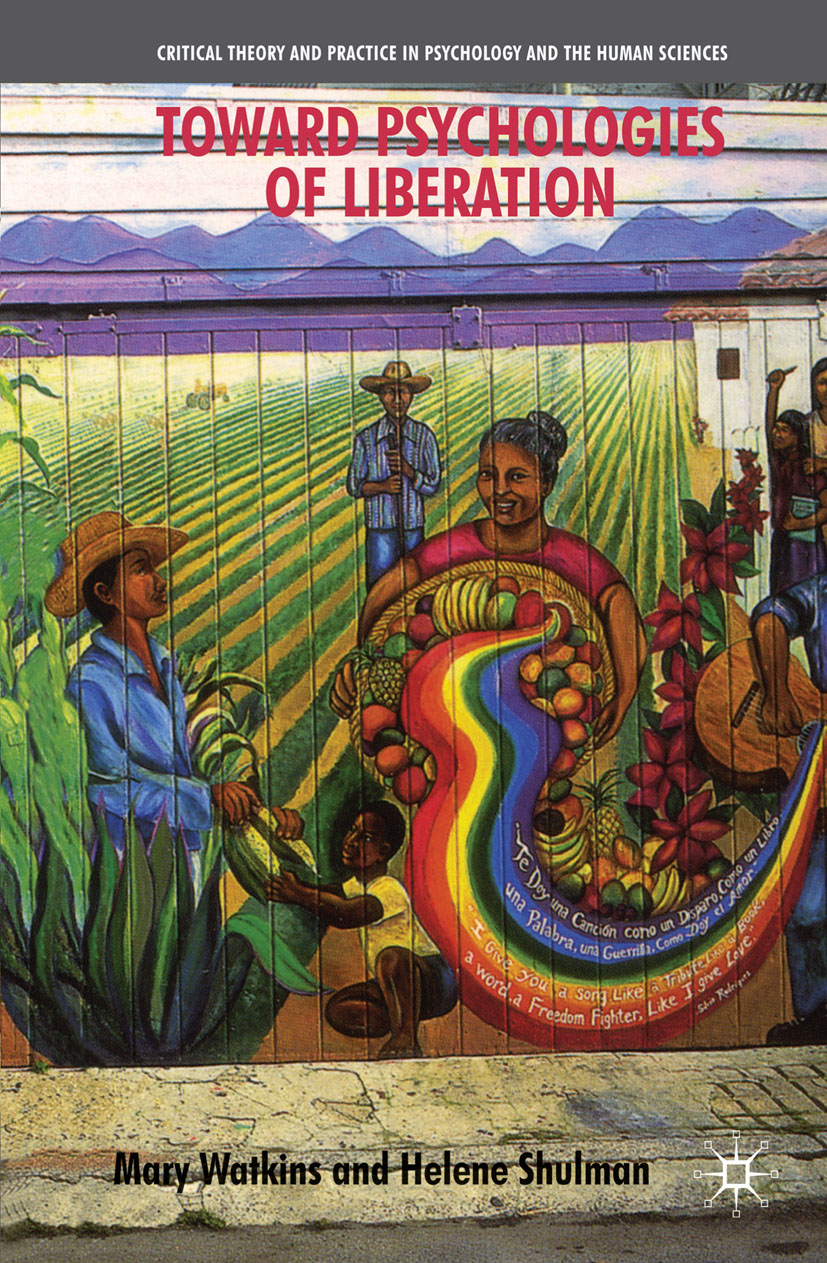
Toward Psychologies of Liberation Psychologies of liberation are emerging on every continent in response to the collective traumas inflicted by colonialism and globalization. The authors present the theoretical foundation and participatory methodologies that unite these radical interdisciplinary approaches to creating individual and community well-being. They move from a description of the psychological and community wounds that are common to unjust and violent contexts to engaging examples of innovative community projects from around the world that seek to heal these wounds. The creation of public homeplaces, and the work of liberation arts, critical participatory action research, public dialogue, and reconciliation are highlighted as embodying the values and hopes of liberation psychology. Drawing on psychoanalysis, trauma studies, liberation arts, participatory research, and contemporary cultural work, this book nourishes our understanding of and imagination about the kinds of healing that are necessary to the creation of more just and peaceful communities. In dialogue with cultural workers, writers, and visionaries from Latin America, Africa, Asia, Europe, the United States, and the Pacific Islands, Toward Psychologies of Liberation quickens a dialogical convergence of liberatory psychological theories and practices that will seed individual and community transformation. POLITICAL SCIENCE,Public Policy,Social Policy
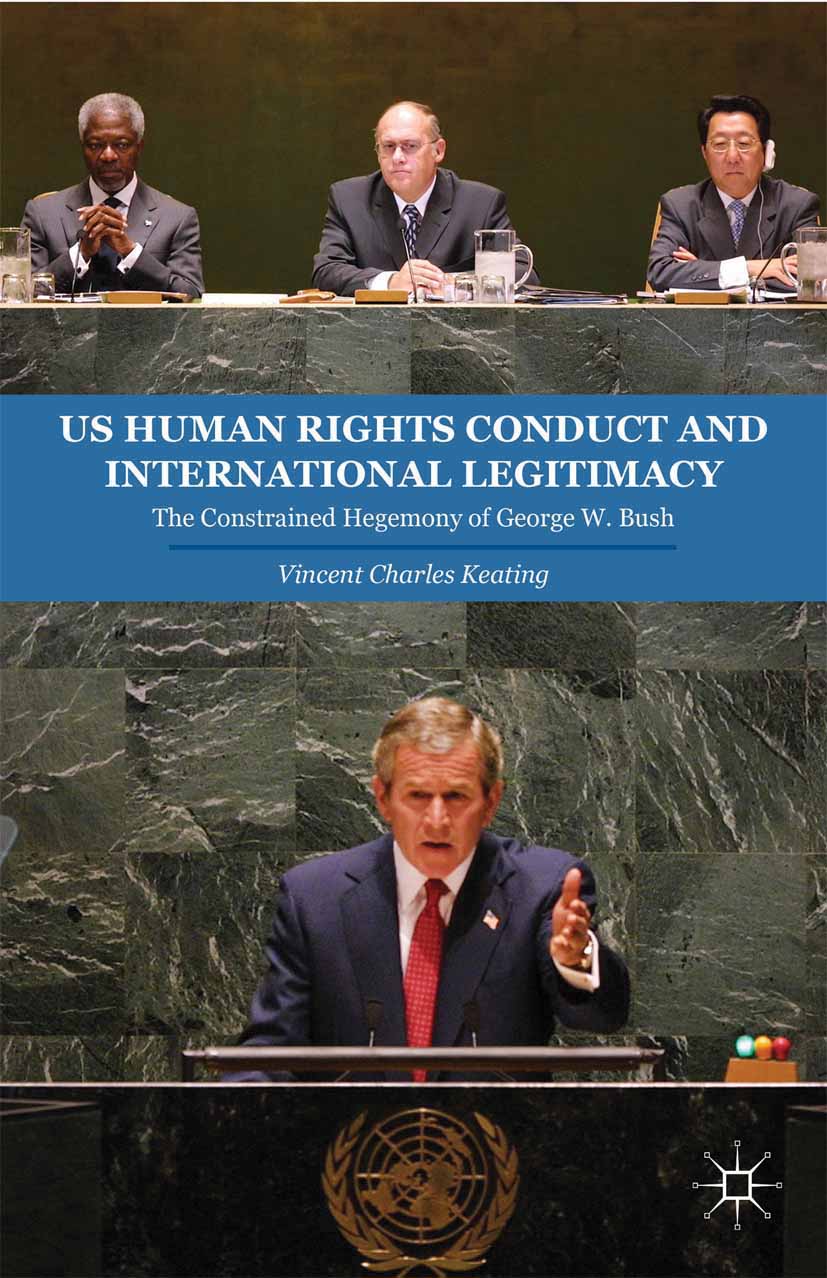
US Human Rights Conduct and International Legitimacy Was the Bush administration was successful in legitimating its preferences with habeas corpus, torture, and extraordinary rendition? As American transforms in the post-Bush era, scholars have begun to assess the post-9/11 period in American foreign and domestic policy, asking difficult questions regarding torture and human rights. POLITICAL SCIENCE,Public Policy,Social Policy
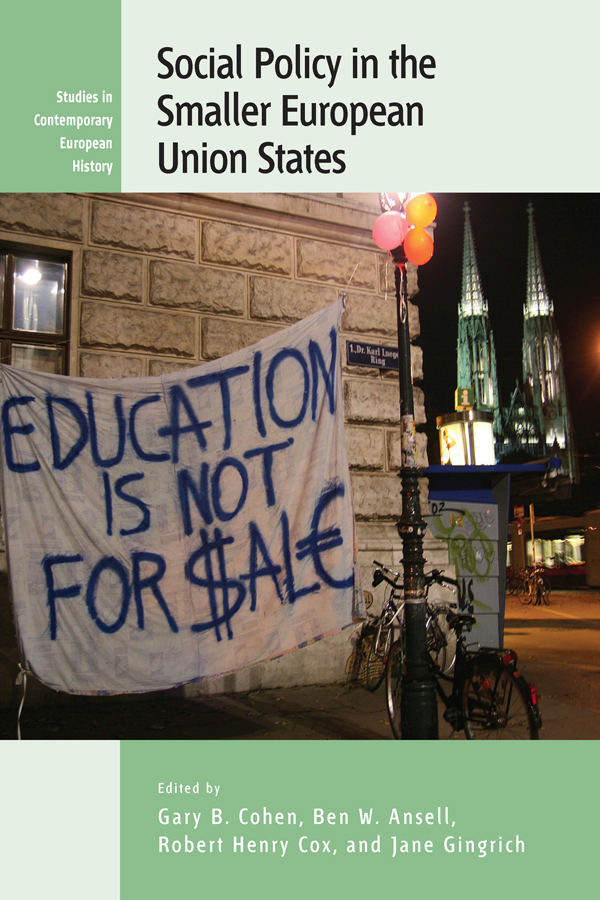
Social Policy in the Smaller European Union States In Europe and around the world, social policies and welfare services have faced increasing pressure in recent years as a result of political, economic, and social changes. Just as Europe was a leader in the development of the welfare state and the supportive structures of corporatist politics from the 1920s onward, Europe in particular has experienced stresses from globalization and striking innovation in welfare policies. While debates in the United Kingdom, Germany, and France often attract wide international attention, smaller European countries—Belgium, Denmark, Austria, or Finland—are often overlooked. This volume seeks to correct this unfortunate oversight as these smaller countries serve as models for reform, undertaking experiments that only later gain the attention of stymied reformers in the larger countries. POLITICAL SCIENCE,Public Policy,Social Policy
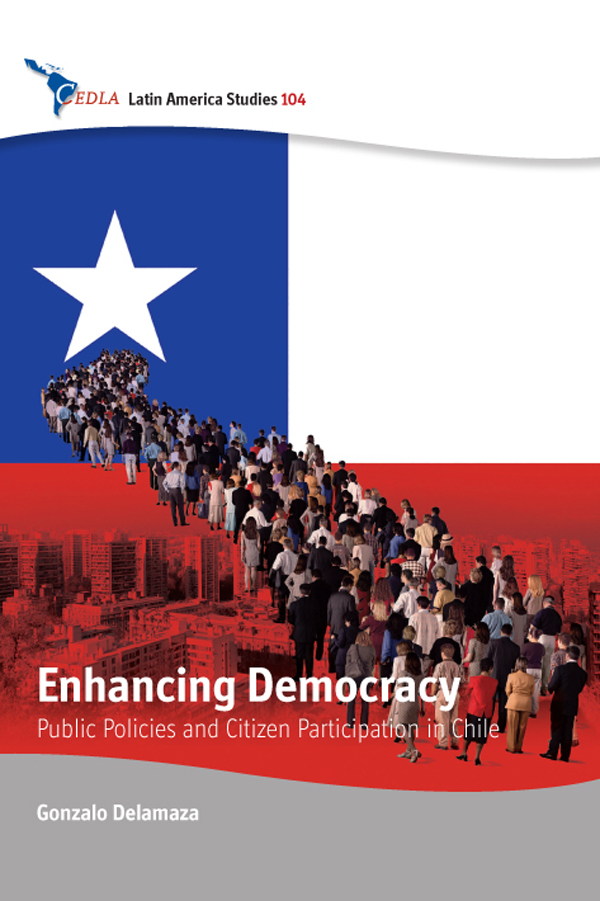
Enhancing Democracy Since the end of the Pinochet regime, Chilean public policy has sought to rebuild democratic governance in the country. This book examines the links between the state and civil society in Chile and the ways social policies have sought to ensure the inclusion of the poor in society and democracy. Although Chile has gained political stability and grown economically, the ability of social policies to expand democratic governance and participation has proved limited, and in fact such policies have become subordinate to an elitist model of democracy and resulted in a restrictive form of citizen participation. POLITICAL SCIENCE,Public Policy,Social Policy
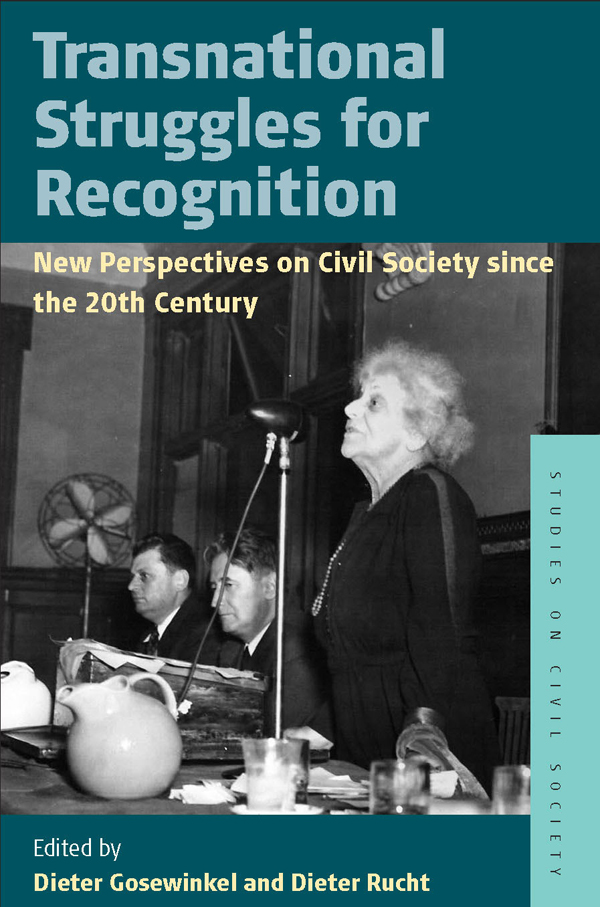
Transnational Struggles for Recognition Now more than ever, “recognition†represents a critical concept for social movements, both as a strategic tool and an important policy aim. While the subject’s theoretical and empirical dimensions have usually been studied separately, this interdisciplinary collection focuses on both to examine the pursuit of recognition against a transnational backdrop. With a special emphasis on the efforts of women’s and Jewish organizations in 20th-century Europe, the studies collected here show how recognition can be meaningfully understood in historical-analytical terms, while demonstrating the extent to which transnationalization determines a movement’s reach and effectiveness. POLITICAL SCIENCE,Public Policy,Social Policy
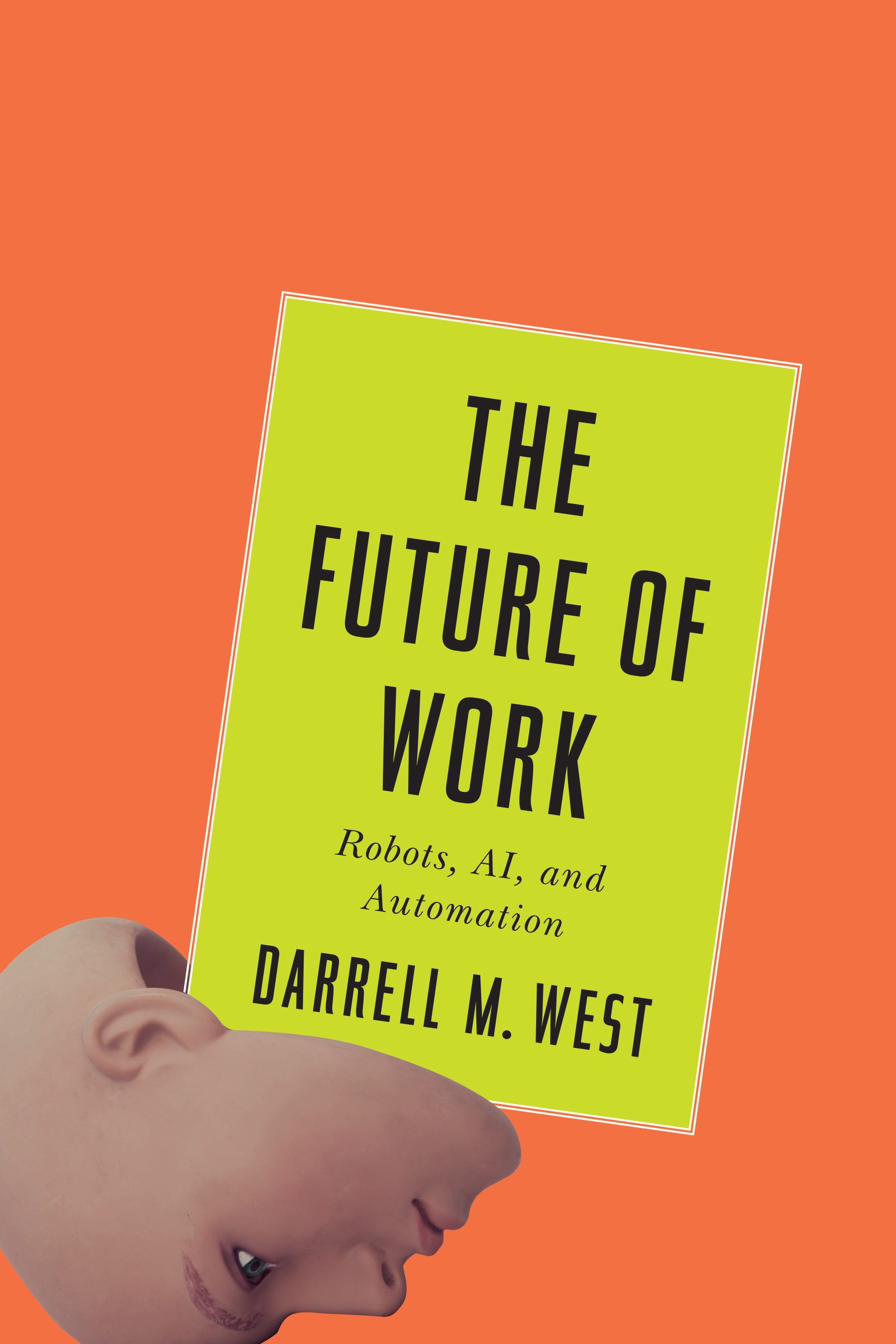
The Future of Work Looking for ways to handle the transition to a digital economy Robots, artificial intelligence, and driverless cars are no longer things of the distant future. They are with us today and will become increasingly common in coming years, along with virtual reality and digital personal assistants. As these tools advance deeper into everyday use, they raise the question—how will they transform society, the economy, and politics? If companies need fewer workers due to automation and robotics, what happens to those who once held those jobs and don't have the skills for new jobs? And since many social benefits are delivered through jobs, how are people outside the workforce for a lengthy period of time going to earn a living and get health care and social benefits? Looking past today's headlines, political scientist and cultural observer Darrell M. West argues that society needs to rethink the concept of jobs, reconfigure the social contract, move toward a system of lifetime learning, and develop a new kind of politics that can deal with economic dislocations. With the U.S. governance system in shambles because of political polarization and hyper-partisanship, dealing creatively with the transition to a fully digital economy will vex political leaders and complicate the adoption of remedies that could ease the transition pain. It is imperative that we make major adjustments in how we think about work and the social contract in order to prevent society from spiraling out of control. This book presents a number of proposals to help people deal with the transition from an industrial to a digital economy. We must broaden the concept of employment to include volunteering and parenting and pay greater attention to the opportunities for leisure time. New forms of identity will be possible when the "job" no longer defines people's sense of personal meaning, and they engage in a broader range of activities. Workers will need help throughout their lifetimes to acquire new skills and develop new job capabilities. Political reforms will be necessary to reduce polarization and restore civility so there can be open and healthy debate about where responsibility lies for economic well-being. This book is an important contribution to a discussion about tomorrow—one that needs to take place today. POLITICAL SCIENCE,Public Policy,Social Policy
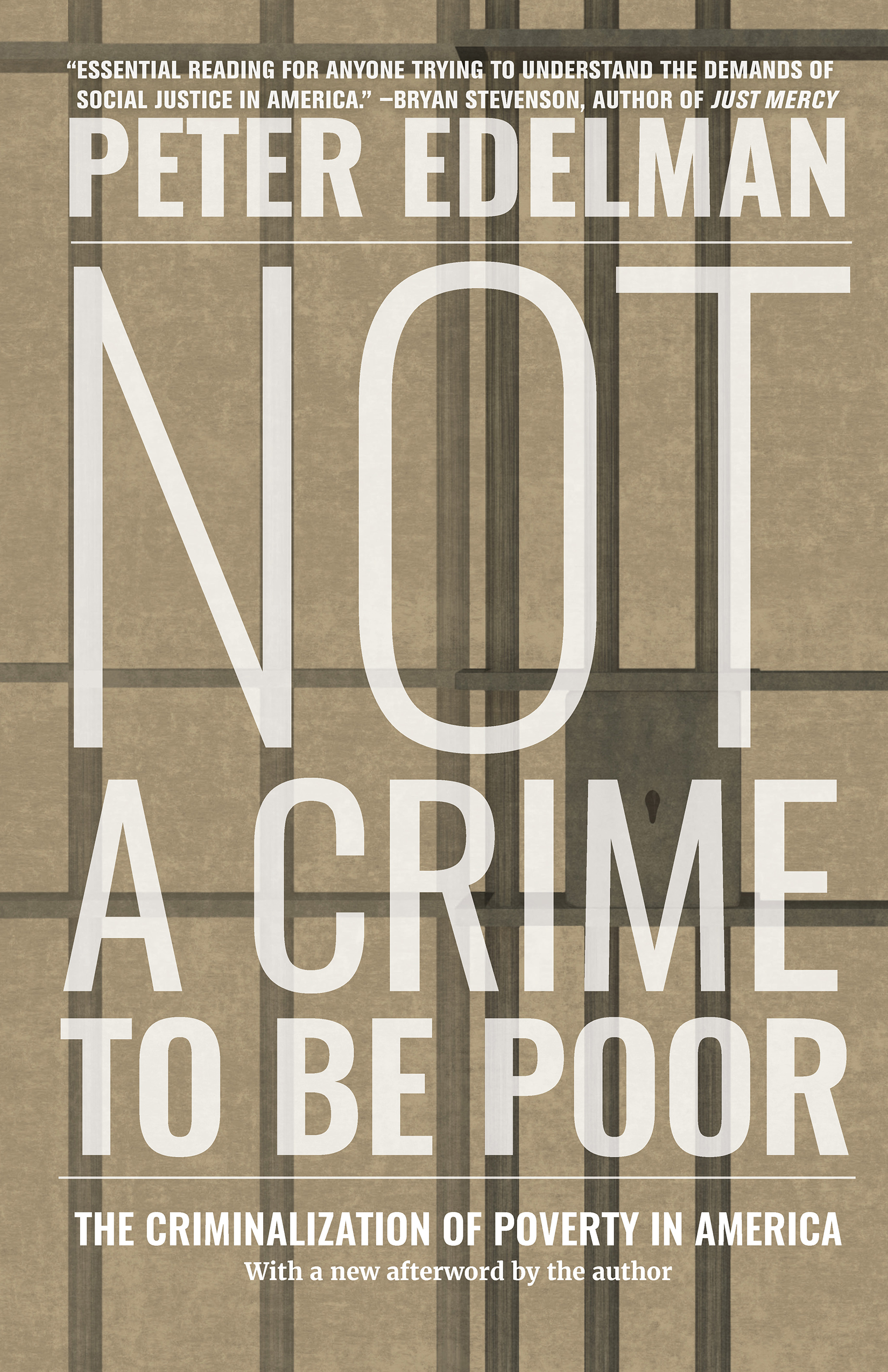
Not a Crime to Be Poor Awarded “Special Recognition†by the 2018 Robert F. Kennedy Book & Journalism Awards Finalist for the American Bar Association’s 2018 Silver Gavel Book Award Named one of the “10 books to read after you've read Evicted†by the Milwaukee Journal Sentinel “Essential reading for anyone trying to understand the demands of social justice in America.â€â€”Bryan Stevenson, author of Just Mercy Winner of a special Robert F. Kennedy Book Award, the book that Evicted author Matthew Desmond calls “a powerful investigation into the ways the United States has addressed poverty . . . lucid and troubling†In one of the richest countries on Earth it has effectively become a crime to be poor. For example, in Ferguson, Missouri, the U.S. Department of Justice didn’t just expose racially biased policing; it also exposed exorbitant fines and fees for minor crimes that mainly hit the city’s poor, African American population, resulting in jail by the thousands. As Peter Edelman explains in Not a Crime to Be Poor, in fact Ferguson is everywhere: the debtors’ prisons of the twenty-first century. The anti-tax revolution that began with the Reagan era led state and local governments, starved for revenues, to squeeze ordinary people, collect fines and fees to the tune of 10 million people who now owe $50 billion. Nor is the criminalization of poverty confined to money. Schoolchildren are sent to court for playground skirmishes that previously sent them to the principal’s office. Women are evicted from their homes for calling the police too often to ask for protection from domestic violence. The homeless are arrested for sleeping in the park or urinating in public. A former aide to Robert F. Kennedy and senior official in the Clinton administration, Peter Edelman has devoted his life to understanding the causes of poverty. As Harvard Law professor Randall Kennedy has said, “No one has been more committed to struggles against impoverishment and its cruel consequences than Peter Edelman.†And former New York Times columnist Bob Herbert writes, “If there is one essential book on the great tragedy of poverty and inequality in America, this is it.†POLITICAL SCIENCE,Public Policy,Social Policy
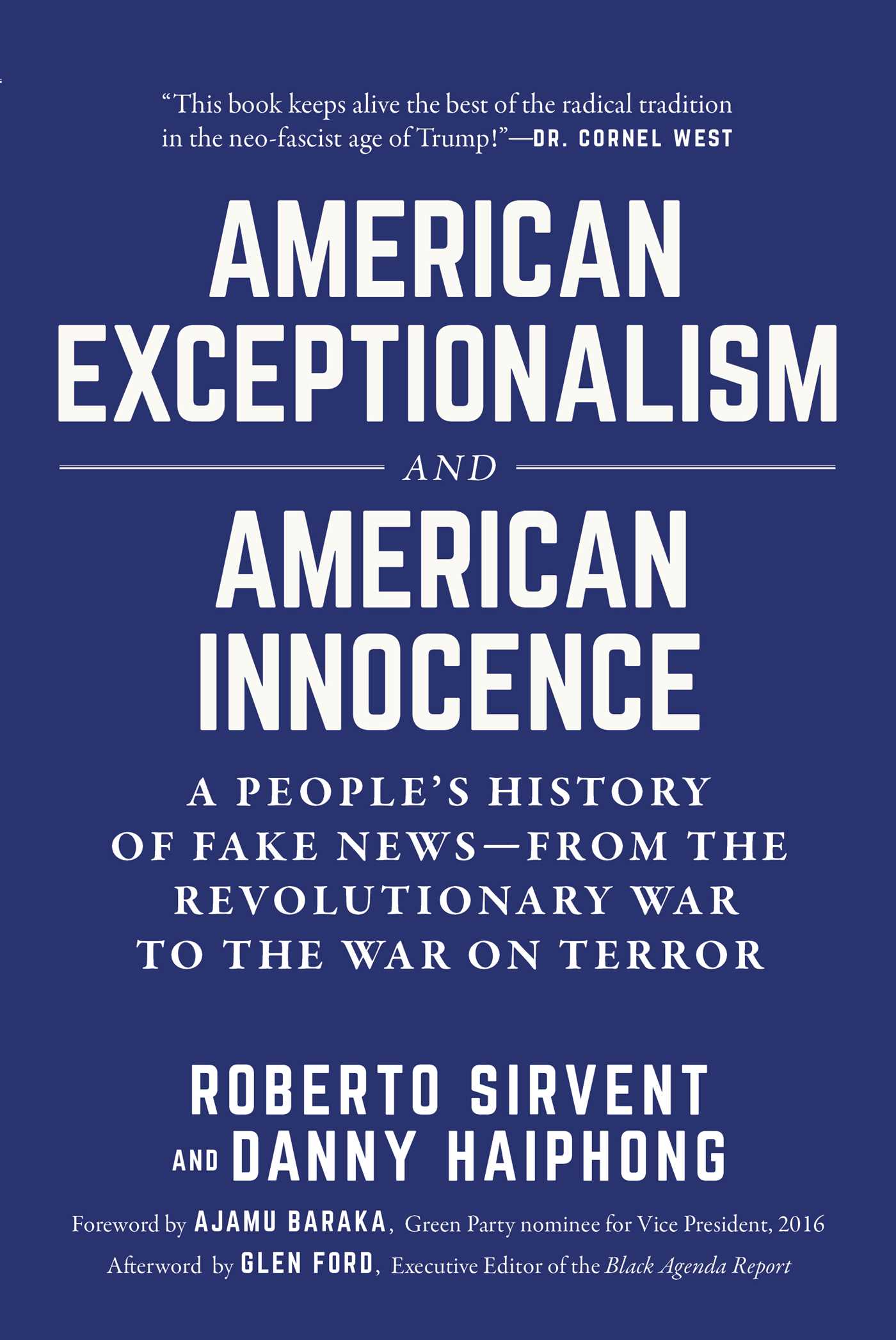
American Exceptionalism and American Innocence “Fake news existed long before Donald Trump…. What is ironic is that fake news has indeed been the only news disseminated by the rulers of U.S. empire.â€â€”From American Exceptionalism and American Innocence According to Robert Sirvent and Danny Haiphong, Americans have been exposed to fake news throughout our history—news that slavery is a thing of the past, that we don’t live on stolen land, that wars are fought to spread freedom and democracy, that a rising tide lifts all boats, that prisons keep us safe, and that the police serve and protect. Thus, the only “news†ever reported by various channels of U.S. empire is the news of American exceptionalism and American innocence. And, as this book will hopefully show, it’s all fake. Did the U.S. really “save the world†in World War II? Should black athletes stop protesting and show more gratitude for what America has done for them? Are wars fought to spread freedom and democracy? Or is this all fake news? American Exceptionalism and American Innocence examines the stories we’re told that lead us to think that the U.S. is a force for good in the world, regardless of slavery, the genocide of indigenous people, and the more than a century’s worth of imperialist war that the U.S. has wrought on the planet. Sirvent and Haiphong detail just what Captain America’s shield tells us about the pretensions of U.S. foreign policy, how Angelina Jolie and Bill Gates engage in humanitarian imperialism, and why the Broadway musical Hamilton is a monument to white supremacy. POLITICAL SCIENCE,Public Policy,Social Policy
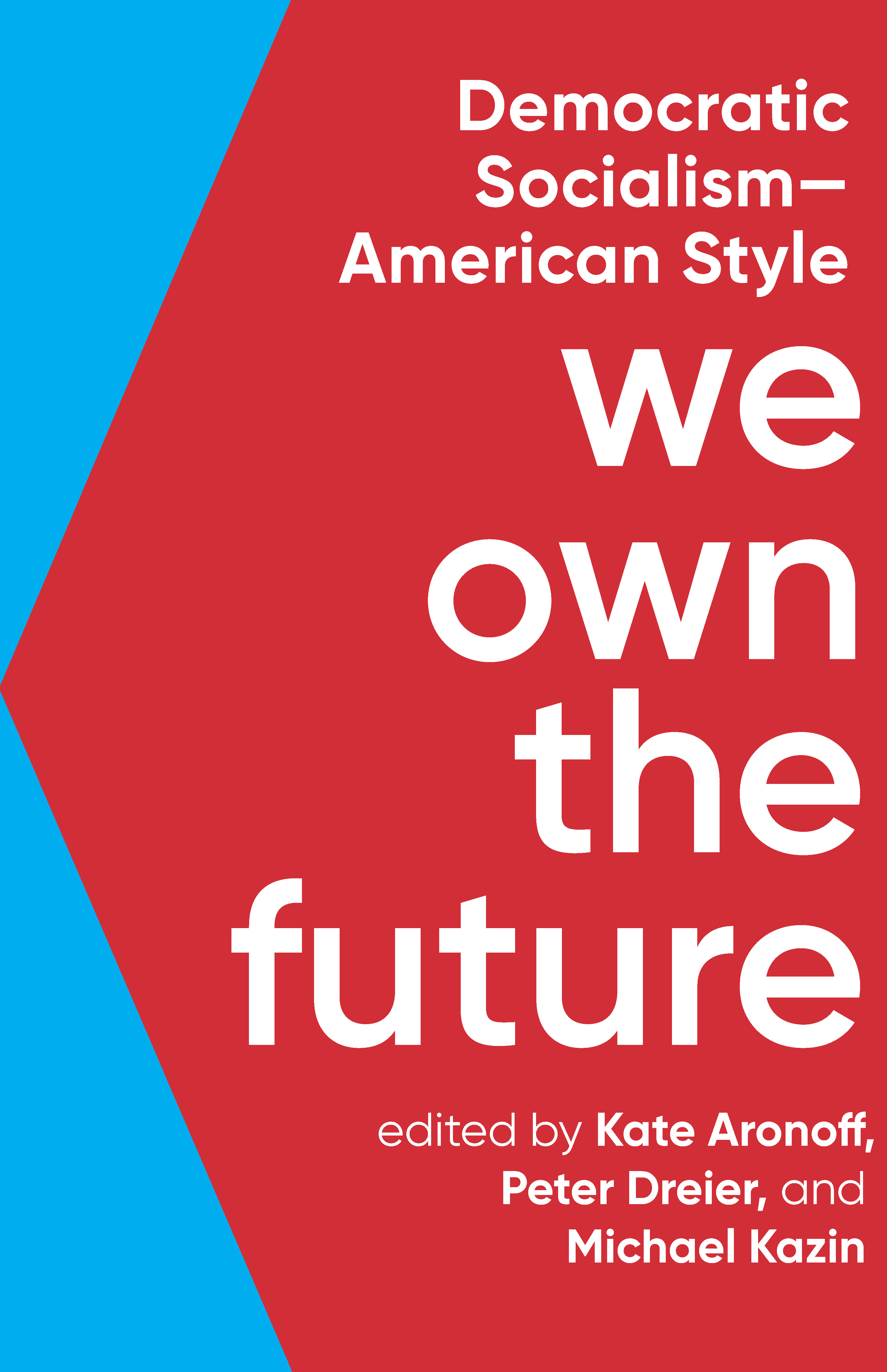
We Own the Future A stunningly original and timely collection that makes the case for “socialism, American style†It’s a strange day when a New York Times conservative columnist is forced to admit that the left is winning, but as David Brooks wrote recently, “the American left is on the cusp of a great victory.†Among Americans under thirty, 43 percent had a favorable view of socialism, while only 32 percent had a favorable view of capitalism. Not since the Great Depression have so many Americans questioned the fundamental tenets of capitalism and expressed openness to a socialist alternative. We Own the Future: Democratic Socialism—American Style offers a road map to making this alternative a reality, giving readers a practical vision of a future that is more democratic, egalitarian, inclusive, and environmentally sustainable. The book includes a crash course in the history and practice of democratic socialism, a vivid picture of what democratic socialism in America might look like in practice, and compelling proposals for how to get there from the age of Trump and beyond. With contributions from some of the nation’s leading political activists and analysts, We Own the Future articulates a clear and uncompromising view from the left—a perfectly timed book that will appeal to a wide audience hungry for change. Table of Contents Part I: Is a New America Possible? Introduction Kate Aronoff, Peter Dreier, and Michael Kazin How Socialists Changed America Peter Dreier and Michael Kazin Toward a Third Reconstruction Andrea Flynn, Susan Holmberg, Dorian Warren, and Felicia Wong A Three-Legged Stool for Racial and Economic Justice Darrick Hamilton Democratic Socialism for a Climate-Changed Century Naomi Klein Part II: Expanding Democracy Governing Socialism Bill Fletcher Jr. We the People: Voting Rights, Campaign Finance, and Election Reform J. Mijin Cha Confronting Corporate Power Robert Kuttner Building the People’s Banks David Dayen Democracy, Equality, and the Future of Workers Sarita Gupta, Stephen Lerner, and Joseph A. McCartin Who Gets to Be Safe? Prisons, Police, and Terror Aviva Stahl On Immigration: A Socialist Case for Open Borders Michelle Chen On Foreign Policy: War from Above, Solidarity from Below Tejasvi Nagaraja Part III: The Right to a Good Life Livable Cities Thomas J. Sugrue What Does Health Equity Require? Racism and the Limits of Medicare for All Dorothy Roberts The Family of the Future Sarah Leonard Defending and Improving Public Education Pedro Noguera Reclaiming Competition: Sports and Socialism David Zirin What About a Well-Fed Artist? Imagining Cultural Work in a Democratic Socialist Society Francesca Fiorentini How Socialism Surged, and How It Can Go Further Harold Meyerson Afterword: A Day in the Life of a Socialist Citizen Michael Walzer POLITICAL SCIENCE,Public Policy,Social Policy
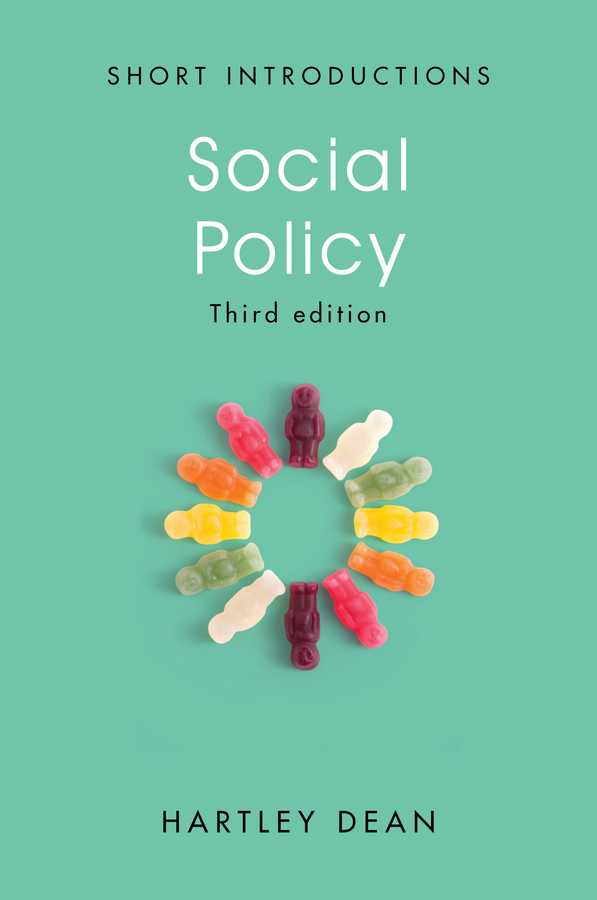
Social Policy How do human societies provide for the wellbeing of their members? How far can we organize the ways in which we care for and about each other? And who should take responsibility for providing the support we need? These are some of the fundamental questions addressed by social policy today. In this introduction, Hartley Dean explains the extraordinary scope and importance of social policy. He explores its foundations and contemporary significance; the principal issues it addresses and their diverse economic, political and sociological dimensions, and concludes by looking anew at fundamental challenges facing social policy in a dramatically changing world. Introducing social policy as a broadly conceived study of human wellbeing, this revised and extensively updated third edition examines ways in which governments and peoples throughout the world attend to, promote, neglect or even undermine the things that make life worth living. These include essential services like healthcare and education; the means of livelihood – jobs and money – and sometimes intangible things such as physical and emotional security. Trying to understand these elements, which together constitute human wellbeing, is the stuff of social policy. POLITICAL SCIENCE,Public Policy,Social Policy
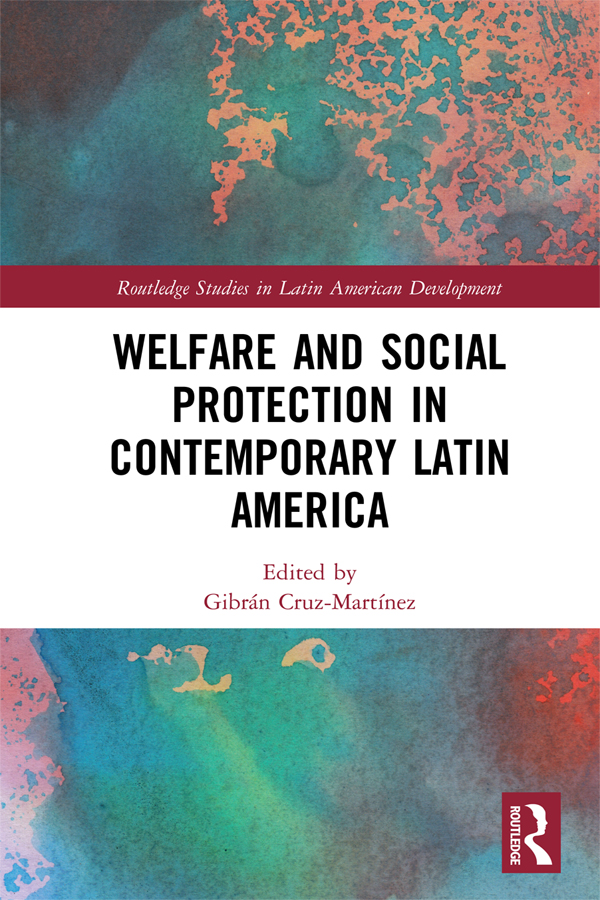
Welfare and Social Protection in Contemporary Latin America Social protection serves as an important development tool, helping to alleviate deprivation, reduce social risks, raise household income and develop human capital. This book brings together an interdisciplinary team of international experts to analyse social protection systems and welfare regimes across contemporary Latin America. The book starts with a section tracking the expansion of social assistance and social insurance in Latin America through the state-led development era, the neoliberal era and the pink-tide. The second section explores the role played by local and external actors modelling social policy in the region. The third and final section addresses a variety of contemporary debates and challenges around social protection and welfare in the region, such as gender roles and the empowerment of CCT beneficiaries, and welfare provision for rural outsiders. The book touches on key topics such as conditional cash transfer programmes, trade union inclusionary strategies, transnational social policy, state-led versus market-led welfare provision, explanatory factors in the emerging dualism of social protection institutions, social citizenship rights as a consequence of changing social policy architecture and different poverty reduction strategies. This interdisciplinary volume will be of interest to economists, political scientists, sociologists, anthropologists and historians working on social protection in Latin America, or interested in welfare systems in the global south. POLITICAL SCIENCE,Public Policy,Social Policy

Make America Healthy Again NATIONAL BESTSELLER! If Americans want to know why their health care is so costly and getting costlier, they need only look in the mirror. Americans are notoriously unhealthy—we eat too much, drink too much, and sit too much. When roughly 80 percent of cardiovascular disease and 40 percent of all cancer cases could be prevented by simple lifestyle changes, it is time to take a deeper look at the problem and ask who is truly responsible. Consider that: · After seventy years of innovation, heart disease and cancer remain the top two causes of death in the United States. · In 1960, health care spending was 5 percent of America's GDP; today, it is 17.5 percent. · The government spends over $1 trillion annually on health care. · Nearly one in five American deaths is associated with poor diets. · Simply reducing sodium intake by 1,200 mg per day could save up to $20 billion a year in medical costs. In Make America Healthy Again, Nicole Saphier, a Memorial Sloan Kettering physician, nationally recognized patient advocate, and media personality, reveals how individual negligence and big government incompetence have destroyed America’s health care system. Combining historical events, economic trends, and essential lifestyle advice, with her unique perspective, she offers concrete solutions to address this epic problem. We don’t need socialized medicine—we need to take better care of ourselves. By getting healthier and adopting preventative measures, Saphier believes, we can reduce the astronomical costs of treatment and improve overall care. The only way to lower medical costs for everyone is to stop incentivizing bad health decisions. Policies such as the Affordable Care Act and single-payer plans ignore something crucial to lowering the overall financial burden: personal responsibility. We can no longer expect doctors and the government to fix illnesses we have the power to prevent. Regardless of which health policy is adopted, our nation will flounder unless we take action. It is up to the American people to make America healthy again. POLITICAL SCIENCE,Public Policy,Social Policy
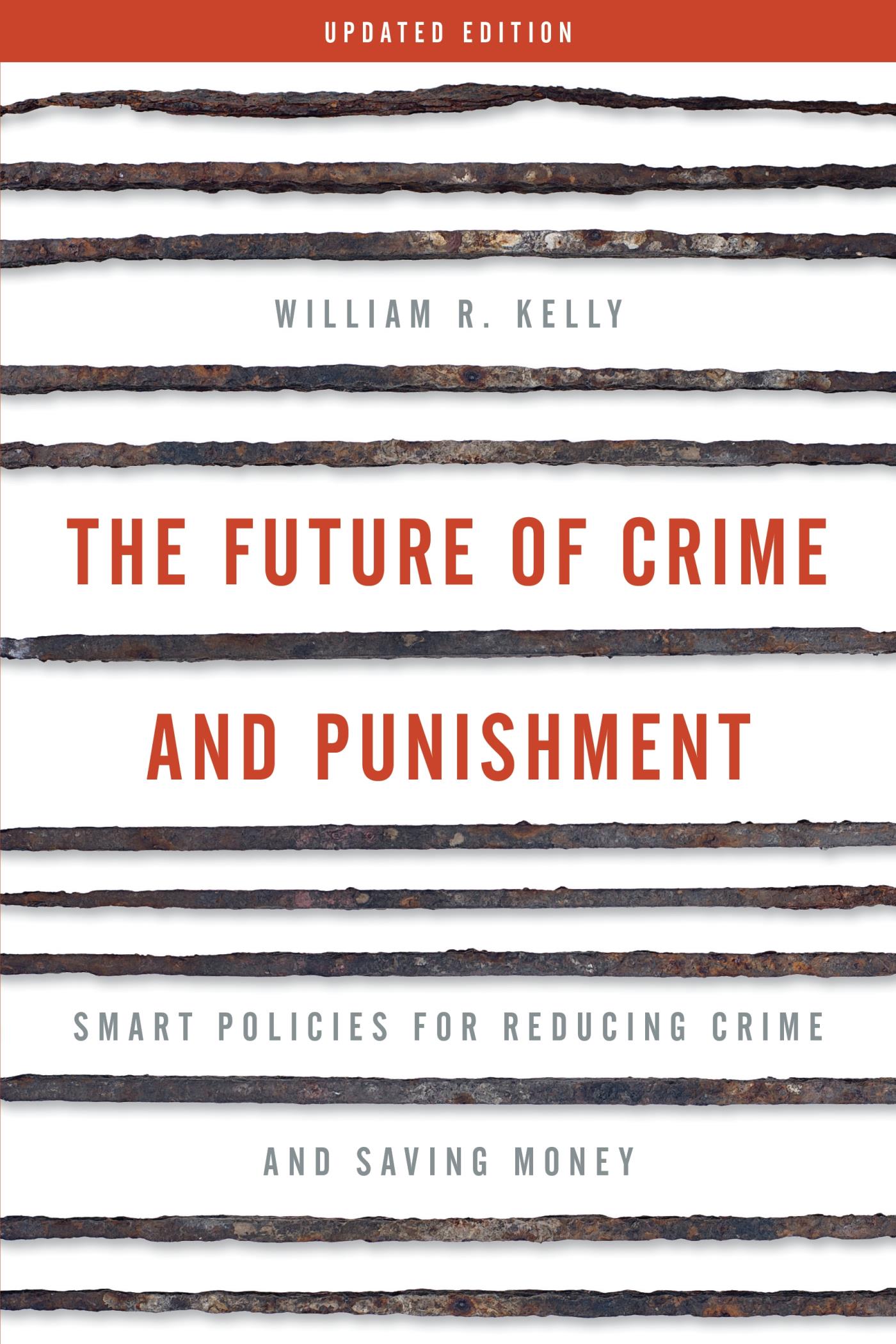
The Future of Crime and Punishment With recidivism rates north of 70% and tens of billions of dollars wasted annually on policies that assume we can punish the crime out of criminal offenders, America’s fixation with “tough on crime†has been an utter failure. William R. Kelly lays out a roadmap for how to effectively reduce recidivism, crime, victimization and cost. POLITICAL SCIENCE,Public Policy,Social Policy
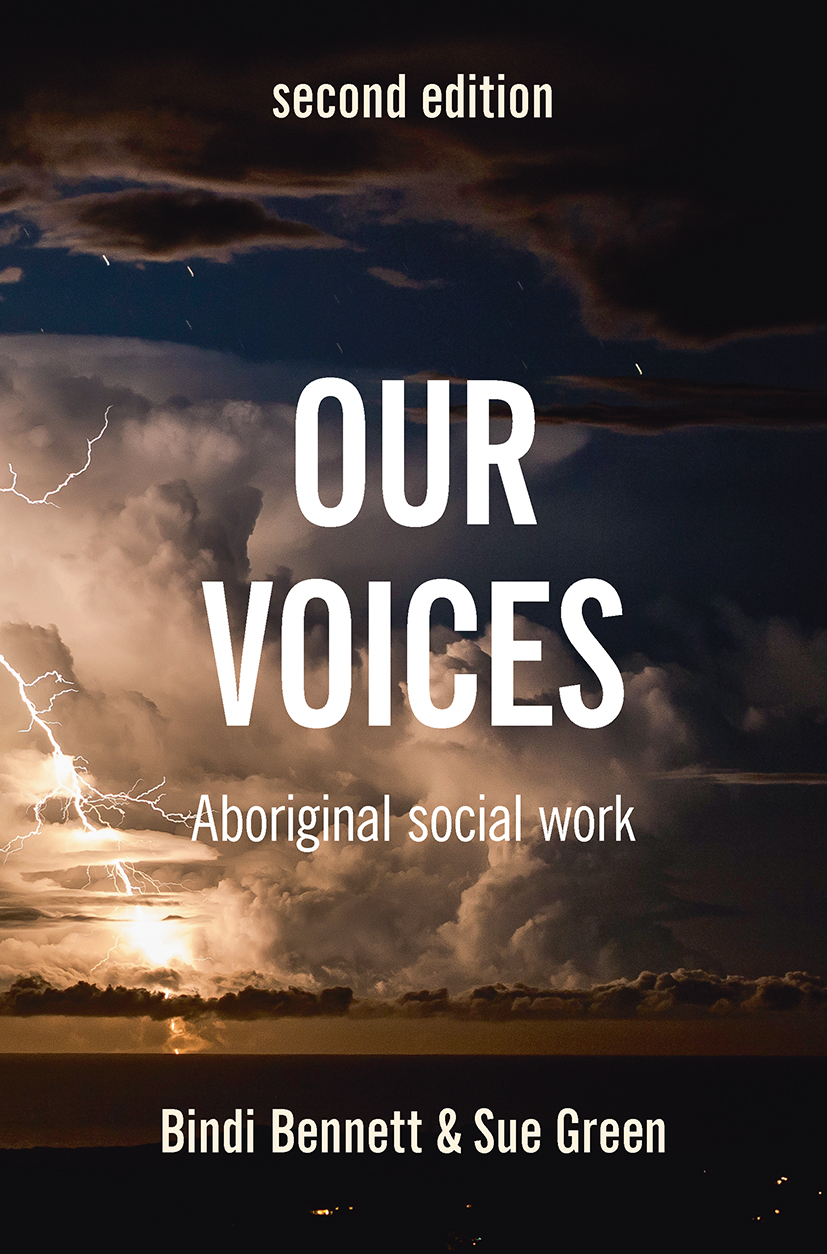
Our Voices The second edition of Our Voices is a ground-breaking collection of writings from Aboriginal social work educators who have collaborated to develop a toolkit of appropriate behaviours, interactions, networks, and intervention. The the text explores a range of current and emerging social work practice issues such as cultural supervision, working with communities, understanding trauma, collaboration and relationship building, and the ubiquity of whiteness in Australian social work. It covers these issues with new and innovative approaches and provides valuable insights into how social work practice can be developed, taught and practiced in ways that more effectively engage Indigenous communities. POLITICAL SCIENCE,Public Policy,Social Policy

Marijuana From Reefer Madness to legal purchase at the corner store With long-time legal and social barriers to marijuana falling across much of the United States, the time has come for an accessible and informative look at attitudes toward the dried byproduct of Cannabis sativa. Marijuana: A Short History profiles the politics and policies concerning the five-leaf plant in the United States and around the world. Millions of Americans have used marijuana at some point in their lives, yet it remains a substance shrouded by myth, misinformation, and mystery. And nearly a century of prohibition has created an enforcement system that is racist, and the continuing effects of racially-targeted over criminalization limit economic and social opportunities in communities of color. Marijuana: A Short History tells this story, and that of states stepping up to enact change. This book offers an up-to-date, cutting-edge look at how a plant with a tumultuous history has emerged from the shadows of counterculture and illegality. Today, marijuana has become a remarkable social, economic, and even political forcewith a surprising range of advocates and opponents. Over the past two decades marijuana policy has transformed dramatically in the United States, as dozens of states have openly defied the federal government. Marijuana: A Short History provides a brief yet compelling narrative that discusses the social and cultural history of marijuana but also tells us how a once-vilified plant has been transformed into a serious, even mainstream, public policy issue. Focusing on politics, the media, government, racism, criminal justice, and education, the book describes why public policy has changed, and what that change might mean for marijuana’s future place in society. POLITICAL SCIENCE,Public Policy,Social Policy
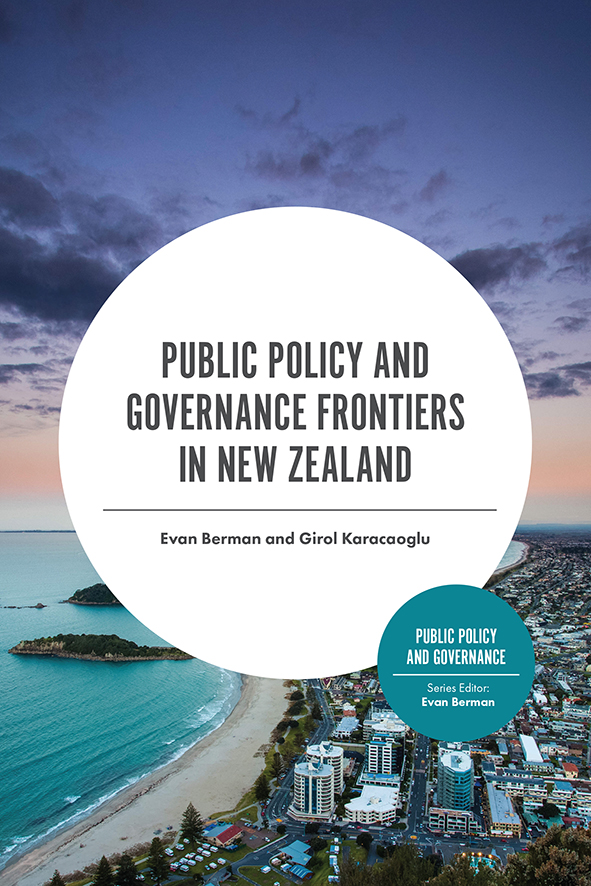
Public Policy and Governance Frontiers in New Zealand New Zealand is widely regarded as a leader in public policy and governance reforms and innovations, being an early adopted of New Public Management, a leader in e-government and transparency. Discussing reforms including those in policy areas such as well-being, sustainability, environmental management, agriculture and indigenous development. POLITICAL SCIENCE,Public Policy,Social Policy

Temporary Agency Workers in Italy and the UK This book offers a comparative exploration of the various disadvantages experienced by a category of atypical workers compared to standard employees, in the UK and Italy, and considers whether and how the differences can be attributed to contrasting institutional settings and political economies. Bertolini explores the lived experience of these workers, and demonstrates how institutional variables interact in complex ways with individual socio-demographic characteristics as well as the broader socio-economic context to shape individual disadvantages and engender different experiences of precariousness. Temporary Agency Workers in Italy and the UK will be of interest to students and scholars of political economy, sociology of work, welfare studies, labour market policy, and industrial relations. POLITICAL SCIENCE,Public Policy,Social Policy

Community Eldercare Ecology in China Informed by the social-ecological framework, this book focuses on the development of Home and Community Based Services (HCBS) in urban China. Bringing a timely discussion around HCBS development in Shanghai, it presents an interplay of formal caregiving relationships, evolving caregiving culture, and the trajectory of long-term care in China. Drawing on surveys, in-depth interviews, and government archives, this book explores the emergence of one of the most developed HCBS programs in Shanghai, its development over the past decade, its administration and services, resource allocation, staff members’ work experiences, older adults’ service experiences, as well as service evaluation and improvements. Offering fresh insight into new forms of caregiving in community settings, and shaping a new discourse on caregiving policy, this book is a key read for both students and practitioners in the fields of long-term care, gerontology, geriatrics, health care, and health policy. POLITICAL SCIENCE,Public Policy,Social Policy
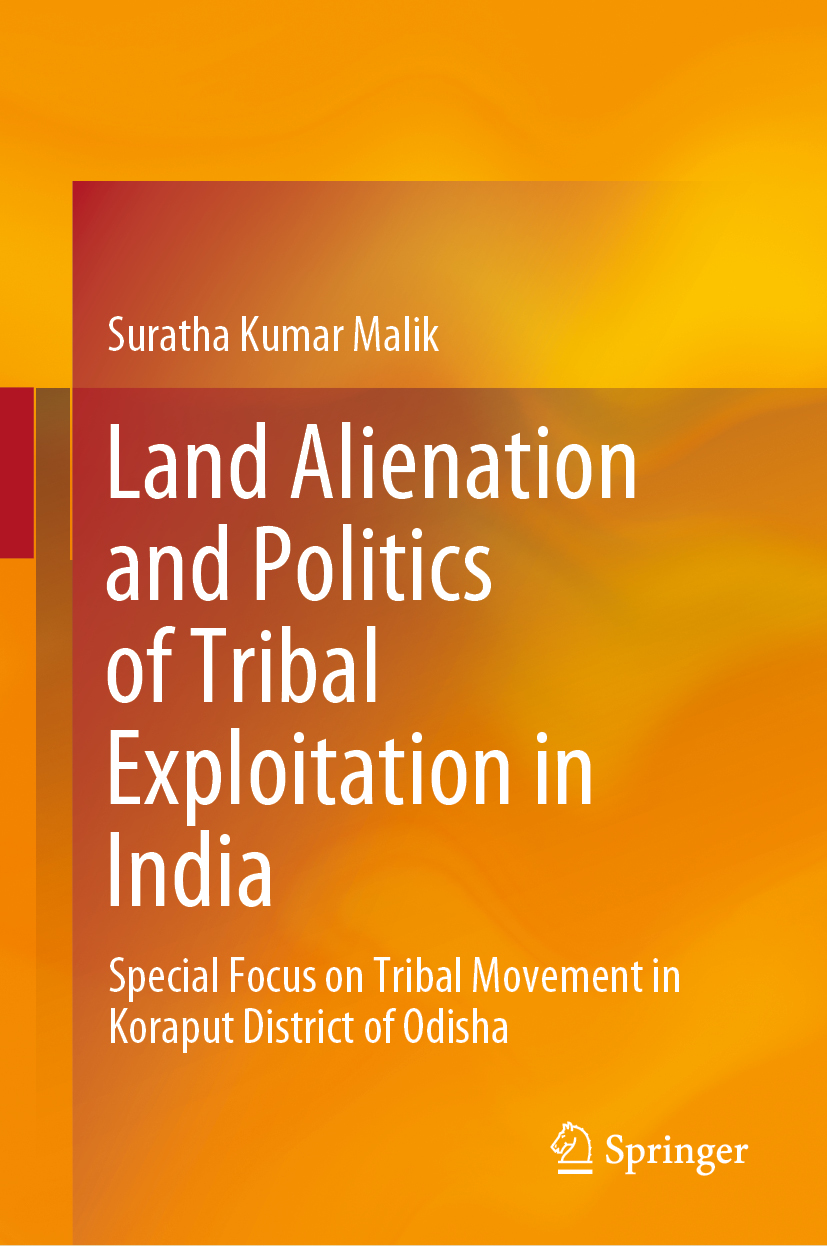
Land Alienation and Politics of Tribal Exploitation in India This book explores tribal land alienation problems in India and tribal agitation against land encroachment and alienation. It discusses India’s tribal land problem and explains how despite legislation to protect tribal lands, the problem has not been resolved since neither the letter nor the spirit of the law has been implemented. Due to continuous land encroachment and alienation by outsiders, the negligence of the revenue administration and the apathy of the central and state government, the situation concerning tribal land in the country have became precarious. In this context, the book highlights the process of land estrangement among the tribes and the related movements, focusing on the Narayanpatna land movement in the Koraput district of Odisha. It argues that land remains a central issue that is extremely important for tribes as it directly affects their life, livelihood, freedom and development, and that the cultural attachment of tribes and their views regarding the idea of ‘place’ (land) furnishes crucial perspectives in understanding the politics of collective resistance. It also discusses the politicization of group identity and material interest against the outside authority as the basis of the unrest among the tribes, and when the grudges of the people are hardened due to insensitivity and tyranny, the extent of tribal resistance escalates, leading to conflict between the state and its own people. Given its scope, this book is a valuable resource for students and research scholars, as well as for policymakers and anyone interested in Indian democracy and development in general, and tribal problems, issues and politics in particular. POLITICAL SCIENCE,Public Policy,Social Policy
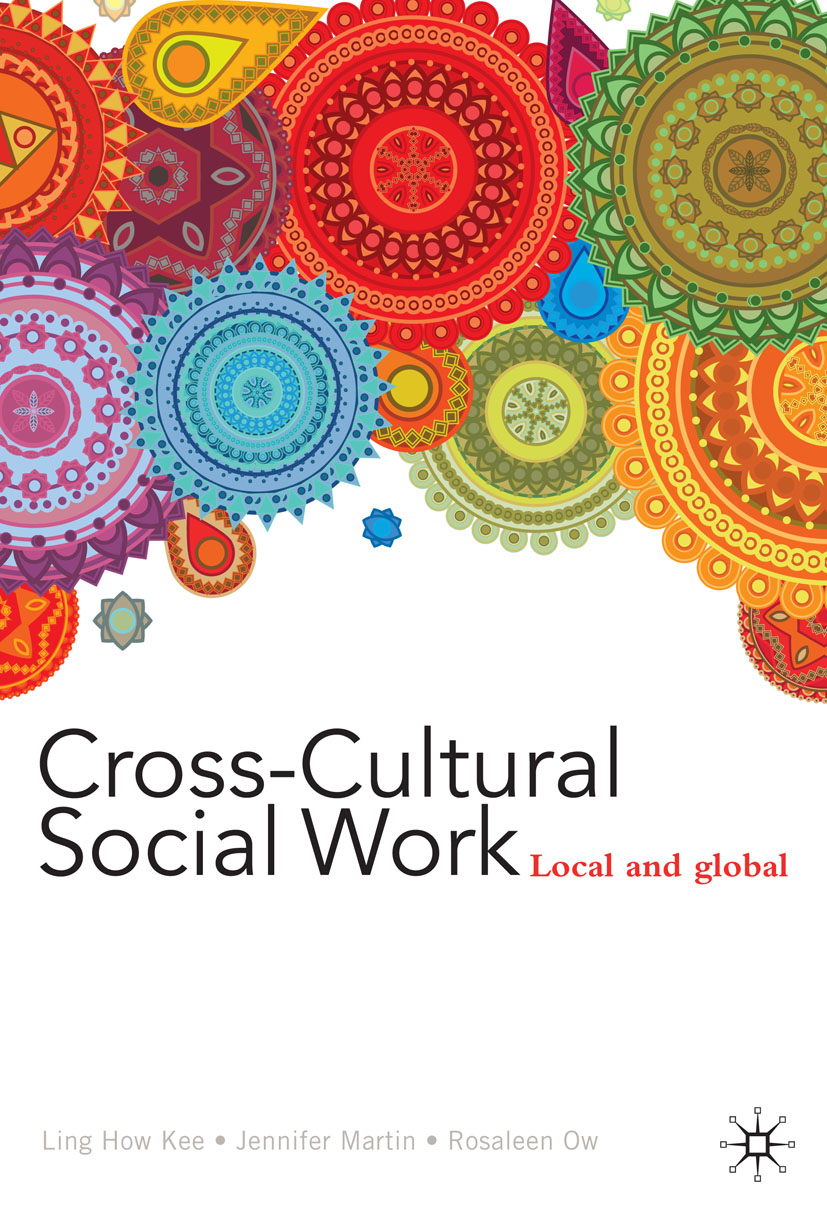
Cross-Cultural Social Work The world is now a global village, yet cultural diversity is at the forefront of social work practice within and across countries. Professional social workers in different countries increasingly have to relate to a multicultural society, and to develop culturally relevant and appropriate practices with individuals and families, groups and communities. In addition, social workers have to work across different national boundaries or with issues which emanate from forces both within and beyond the countries they are from. Social work education therefore has to be able to prepare graduates to work in varying cultural and socio-economic contexts. In two parts, Cross-Cultural Social Work: Local and global addresses contemporary issues that are at the forefront of community care and development. Part 1 discusses theories and perspectives for culturally appropriate practice, education and research, whilst part 2 contains approaches to working with culturally diverse groups and practice areas. Issues addressed in these parts include: Part 1 Culture in social work, cultural competence, whiteness in social work, biculturalism, working with diversity, and culturally based methods of inquiry. Part 2 Marginalised indigenous communities, social and economic barriers, new and emerging communities, end-of-life issues, international adoption, and culturally diverse aged care. Combining theoretical discussions and practical knowledge building materials Cross-Cultural Social Work facilitates the development of cultural competence among social work students, educators, practitioners and researchers. The book engages readers to critically reflect on cultural underpinnings of dominant social work theories and methods, and to challenge the way we think about culture and cross-cultural practice. Key Features • A collection of works from contributors from different practice settings and different countries which facilitates the development of 'cultural competence' among social work students and educators, practitioners and researchers • Reflects the stipulations of professional accreditation bodies, such as the Australian Association of Social Workers, to include cross-cultural practice as well as standards of practice with minority communities in curriculum content • Combines theoretical discussions and practical knowledge building materials to aid in understanding theories in practice and prepare graduates to work in varying cultural and socio-economic contexts. POLITICAL SCIENCE,Public Policy,Social Policy
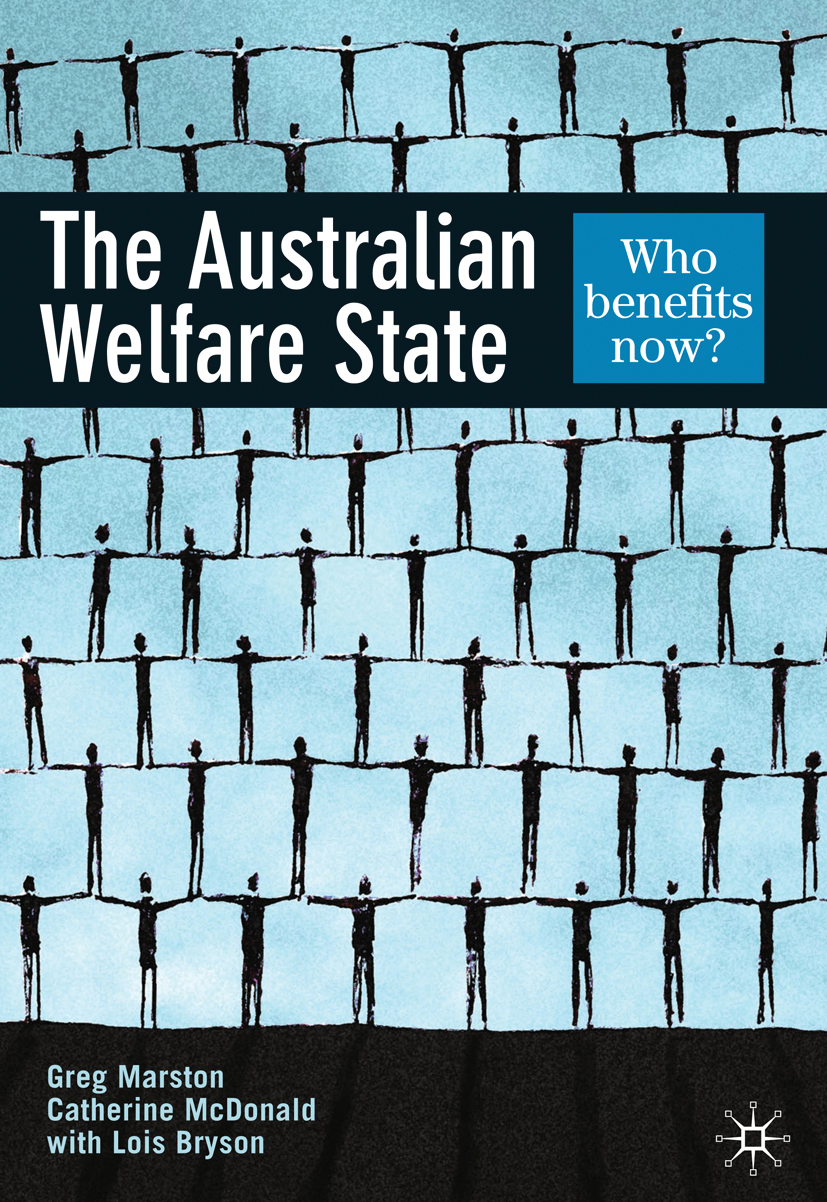
The Australian Welfare State In 1992, Australian sociologist Lois Bryson published what proved to be an important book entitled Welfare and the State: Who benefits? The central feature of this text was an exploration of the actual, as opposed to assumed, nature of the redistribution of resources via the Australian welfare state. Following on from Bryson’s work, The Australian Welfare State: Who benefits now? assesses trends in poverty and inequality in Australia from 1992 to the present and describes and evaluates the institutions that make up the Australian welfare state. Taking Bryson’s initial analysis as the baseline, this title illustrates the major structural and institutional developments in the Australian welfare state, and in the Australian economy and society, over this same period. It analyses political and policy responses to poverty and inequality in Australia and assesses the extent and direction of redistribution in key areas of state activity. This text definitively outlines the links between Australians’ conceptions about welfare and the redistributive outcomes of the welfare state, canvassing theoretical explanations about why many Australians develop and maintain misconceptions of the broad distributive mechanisms of the Australian welfare state and hold negative attitudes towards its social welfare element. Containing a number of pedagogical features including case studies, exercises, excerpts from Government agencies, and discussion questions, The Australian Welfare State is an indispensable resource for students undertaking studies in social policy from a range of disciplinary perspectives including sociology, public administration, economics and social work. POLITICAL SCIENCE,Public Policy,Social Policy
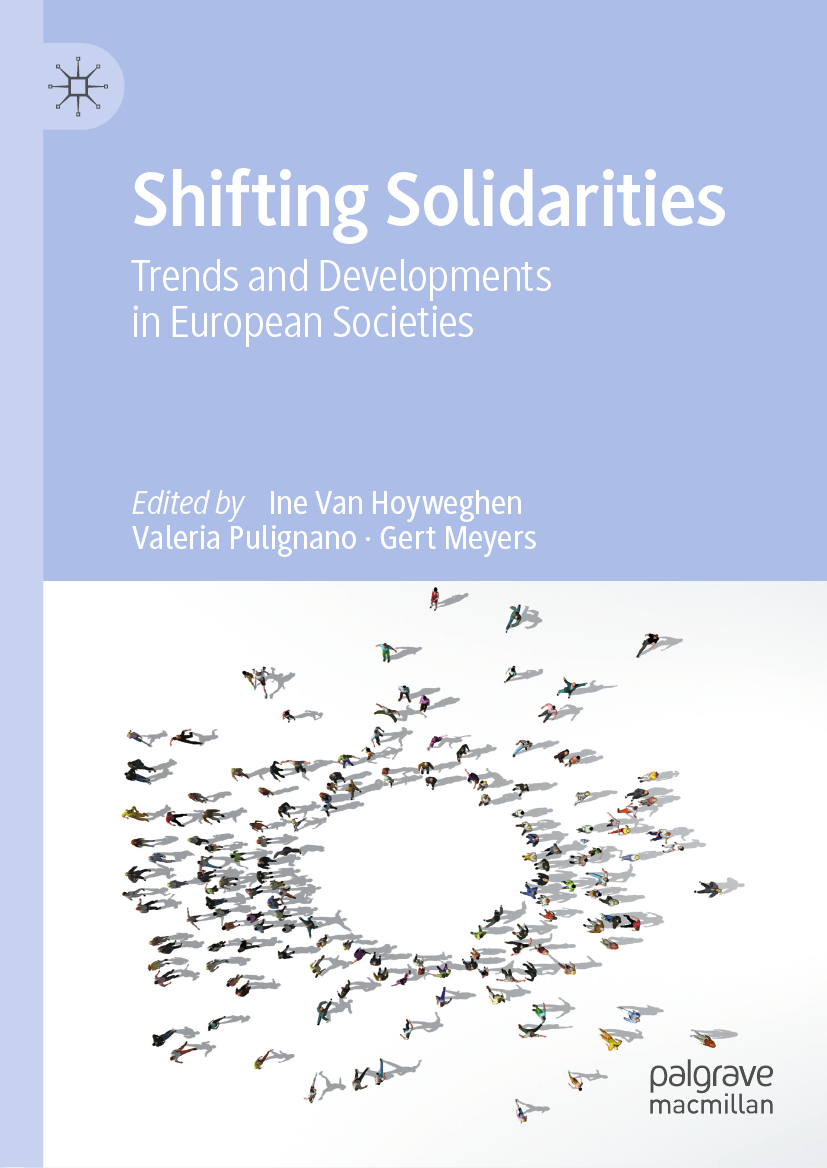
Shifting Solidarities Shifting Solidarities offers a comprehensive analysis of solidarity at a time when major social transformations have penetrated the heart of European societies, disrupting markets and labour relations, transforming social practices, and affecting the moral infrastructure of European welfare states. Factors such as the economic crisis, migration, digitalisation, and climate change all contribute to a sense of emergency. This volume considers how, in times of crisis, there are calls for solidarity by various new social and political actors and movements. The contributions present a broad array of empirical work and critical scholarship, zooming in on shifting solidarities in various domains of social life, including work, social policy, health care, religion, family, gender and migration. This compelling volume provides a unique resource for understanding solidarity in contemporary Europe, and will be a vital text for students and scholars across sociology, social policy, cultural studies, employment/labour markets and organisation studies, migration studies and European studies. POLITICAL SCIENCE,Public Policy,Social Policy

Social Policy This thoroughly revised and expanded new edition provides a comprehensive introduction to contemporary social policy and addresses its historical, theoretical and contextual foundations as well as contemporary policy issues relating to health, education and welfare as well as the impact of Brexit. Divided into four sections, it opens with a survey of the socio-economic, political and governmental contexts within which social policy operates, before moving on to look at the historical development of the subject. The third section examines contemporary aspects of providing welfare, whilst the final part covers European and wider international developments. The text explores the major topics and areas in contemporary social policy, for example: work and welfare education adult health and social care children and families crime and criminal justice health housing race disability social care and includes new chapters on class as well as comparative social policy. Issues are addressed throughout in a lively and accessible style and examples are richly illustrated to encourage the student to engage with theory and content and to help highlight the relevance of social policy in our understanding of modern society. It is packed with features including ‘Spotlight’ ‘Discussion and review’ and ‘Controversy and debate’ boxes, as well as further readings and recommended websites. A comprehensive glossary also provides explanations of key terms and abbreviations. This is an essential textbook for undergraduate students taking courses in social policy and related subjects such as criminology, health studies, politics, sociology, nursing, youth and social work. POLITICAL SCIENCE,Public Policy,Social Policy
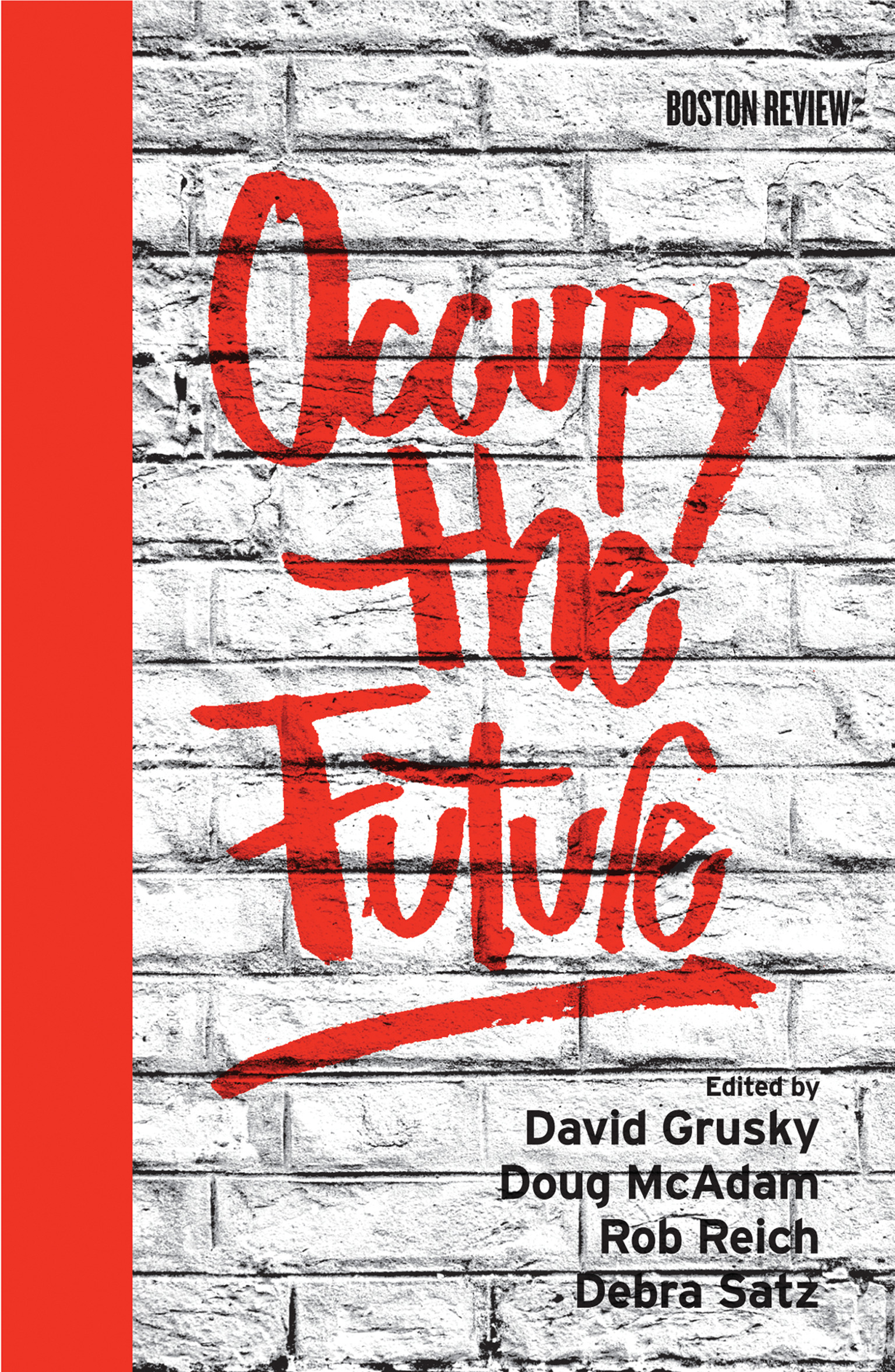
Occupy the Future How the Occupy movement has challenged the gap between American principles and American practice—and how we can realize our most cherished ideals. The Occupy Wall Street movement has ignited new questions about the relationship between democracy and equality in the United States. Are we also entering a moment in history in which the disjuncture between our principles and our institutions is cast into especially sharp relief? Do new developments—most notably the rise of extreme inequality—offer new threats to the realization of our most cherished principles? Can we build an open, democratic, and successful movement to realize our ideals? Occupy the Future offers informed and opinionated essays that address these questions. The writers—including Nobel Laureate in Economics Kenneth Arrow and bestselling authors Paul and Anne Ehrlich—lay out what our country's principles are, whether we're living up to them, and what can be done to bring our institutions into better alignment with them. Contributers: David Grusky, Doug McAdam, Rob Reich, Erin Cumberworth, Debra Satz, Kenneth J. Arrow, Kim A. Weeden, Sean F. Reardon, Prudence L. Carter, Shelley J. Correll, Gary Segura, David D. Laitin, Cristobal Young, Charles Varner, Doug McAdam, Paul R. Ehrlich, Anne H. Ehrlich, Paul R. Ehrlich and Anne H. Ehrlich, Donald A. Barr, Michele Elam, Jennifer DeVere Brody, H. Samy Alim and David Palumbo-Liu. POLITICAL SCIENCE,Public Policy,Social Policy

Security Dilemmas and Challenges in 21st Century Asia This book analyzes current security challenges in Asia (understood in its broader Indo–Pacific sense) with the aim of capturing the major shifts in the balance of power involving regional actors. Through the lenses of IR theory, this book seeks to provide insights into the consequences of the transition of power from the United States to China. The growing power of China and its impact on both neighboring countries and the international system as a whole, as well as its reception by the United States, have been of key importance to the development of security and international studies. By presenting the case studies of regional security challenges from a multidimensional perspective, this book analyzes both the stages of the maturity of powers and their satisfaction within the existing system. POLITICAL SCIENCE,Public Policy,Social Policy
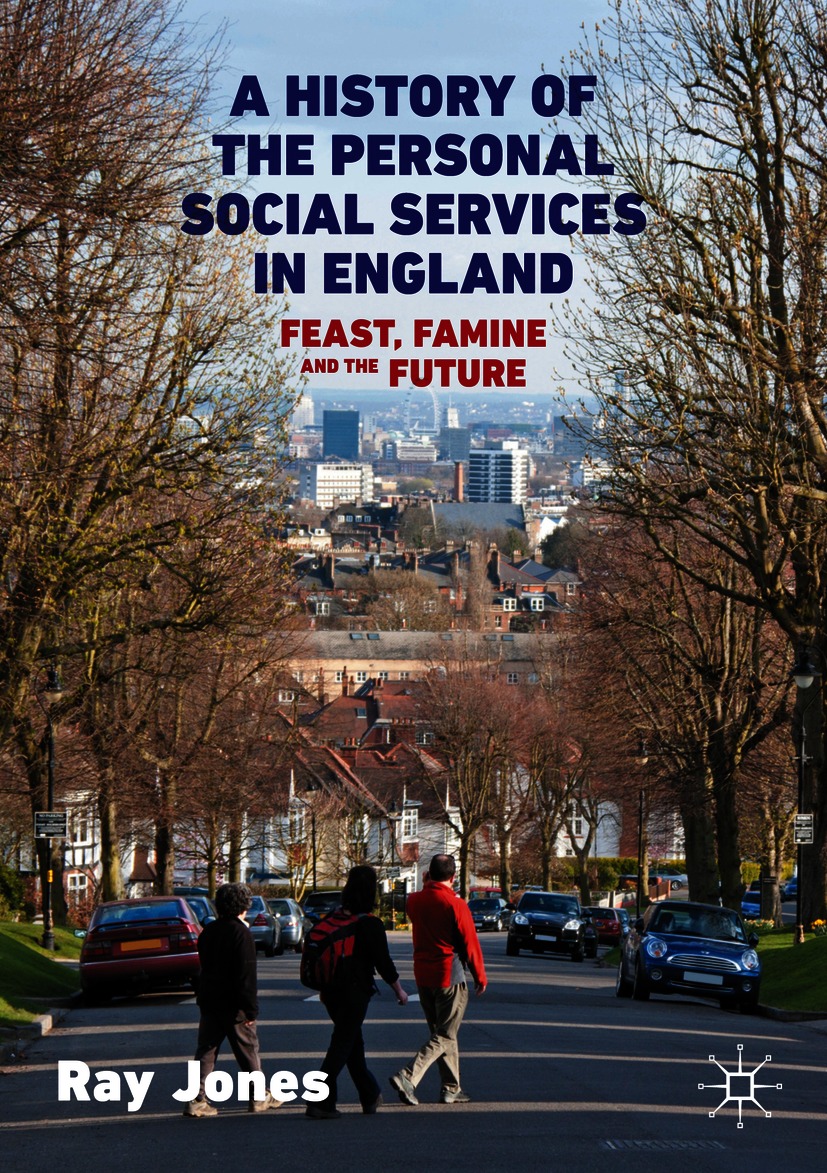
A History of the Personal Social Services in England This book provides a detailed narrative and analysis of the 50-year development of the personal social services in England, located throughout the changing ideological, political and relevant professional contexts of the period. Drawing on the experience and recollections of key players who were active during major moments, it constitutes a significant addition to the social work and social policy literature, synthesising important and often original evidence, and some provocative interpretations. The book speaks to crucial on-going issues and contentious current debates, such as the place of bureaucratic management structures in ‘practices with people' generally, and social work specifically. It will be of interest to student and qualified social workers, social policy students and researchers, and policy makers, as well as those with a general interest in the history and trajectory of current issues facing social work and social care in England. POLITICAL SCIENCE,Public Policy,Social Policy

Rebel City SCMP's reporting team looks back at Hong Kong's most wrenching political crisis since its return to Chinese rule in 1997. Anti-extradition bill protests that morphed rapidly into a wider anti-government movement in 2019 left no aspect of the city untouched, from its social compact to its body politic to its open economy. The demonstrations which continued well into 2020 have tested every institution of the city, from the civil service to the police to the courts and even its rail transport operator, and from offices and businesses to universities and schools, and from churches to families and even friends.This book is for anyone seeking to understand not just what Hong Kong has gone through but also the global phenomenon of increasingly leaderless protest movements. Fueled by profound angst about the place of millennial youth in society, widening income inequality, and the speed of digital communications, Hong Kong was in retrospect ripe to be the laboratory for a new-age protest movement, nearly a decade after the Middle East's Arab spring.The essays in the book collectively compose a picture of a society in trauma, bent and broken, but showing signs of an uncanny ability to bounce back. What shape it will be in a few years from now, however, is much harder to predict.Related Link(s) POLITICAL SCIENCE,Public Policy,Social Security

Rescuing Retirement Retirement shouldn’t be just for the rich: “Finally, a practical plan to address Americans’ lack of adequate retirement savings.â€â€”Michael Bloomberg Everyone deserves to be able to retire with dignity, but this core feature of the social contract is in jeopardy. Companies have swerved away from pensions, and most of the workforce has woefully inadequate retirement savings. If we don’t act to fix this broken system, rates of impoverishment for senior citizens threaten to skyrocket, and tens of millions of Americans reaching retirement age in the coming decades will be forced to delay retirement and will experience a dramatic drop in their standard of living. In Rescuing Retirement, economist Teresa Ghilarducci and billionaire businessman Tony James offer a comprehensive yet simple plan to help workers save for retirement, increase retirement savings by earning higher returns, and guarantee lifelong income for everyone. Built on people’s own money in individual Guaranteed Retirement Accounts, the plan requires no new taxes, no more bureaucracy, and no increase in the deficit. Speaking to Americans’ growing anxiety about their ability to retire, Rescuing Retirement provides answers to anyone wanting to understand the growing movement to protect a period of life once considered a deserved time of rest and creativity and offers a practical guide to the future of secure retirement. “Ghilarducci and James never slip into wonk-speak or jargon, and lay readers will appreciate the way the authors make sense of complex economic issues.â€â€”Publishers Weekly POLITICAL SCIENCE,Public Policy,Social Security
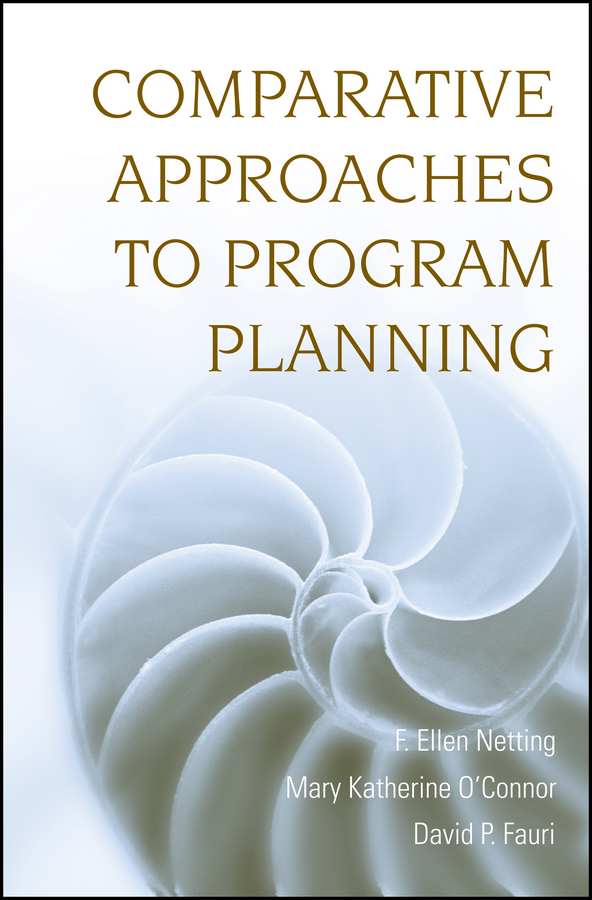
Comparative Approaches to Program Planning "As a practitioner in the field for over thirty years, I have been exposed to endless 'planning' sessions that are prescriptive to the point of being oppressive. Thistext 'gives permission' to the practitioner to allow for emergence, uncertainty, and ambiguity in the planning process. Comparative Approaches to Program Planning provides a guide for the manager, administrator, executive director, strategic planner, and CEO to embrace multiple planning strategies and the understanding of each. This is extremely worthwhile in a dynamic environment and an ever- changing landscape and worldview."—Paul D. McWhinney, ACSW, Director of Social Services City of Richmond, Richmond, Virginia "This is the book I've been waiting for. It provides not only a linear approach to program design, but gives language to the tacit knowledge many planners have of the circular nature of their work. Both linear and circular thinking are important to planning processes and now we have a resource for teaching."—Jon E. Singletary, PhD, MSW, MDiv, Baylor University, School of Social Work The first text on program planning to guide readers in selecting program planning approaches appropriate to setting, culture, and context Valuable for students and practitioners in the social work, public administration, nonprofit management, and community psychology fields, Comparative Approaches to Program Planning provides practical and creative ways to effectively conduct program planning within human service organizations. Written by leaders in the social work education community, this innovative book explores program planning as a multi-layered and complex process. It examines both a traditional linear problem-solving model as well as an alternative emergent approach to program planning, helping professionals to successfully develop and enact effective and culturally competent planning in organizations and communities. POLITICAL SCIENCE,Public Policy,Social Services & Welfare

American Dream In this definitive work, two-time Pulitzer finalist Jason DeParle, author of A Good Provider Is One Who Leaves, cuts between the mean streets of Milwaukee and the corridors of Washington to produce a masterpiece of literary journalism. At the heart of the story are three cousins whose different lives follow similar trajectories. Leaving welfare, Angie puts her heart in her work. Jewell bets on an imprisoned man. Opal guards a tragic secret that threatens her kids and her life. DeParle traces their family history back six generations to slavery and weaves poor people, politicians, reformers, and rogues into a spellbinding epic. With a vivid sense of humanity, DeParle demonstrates that although we live in a country where anyone can make it, generation after generation some families don’t. To read American Dream is to understand why. POLITICAL SCIENCE,Public Policy,Social Services & Welfare
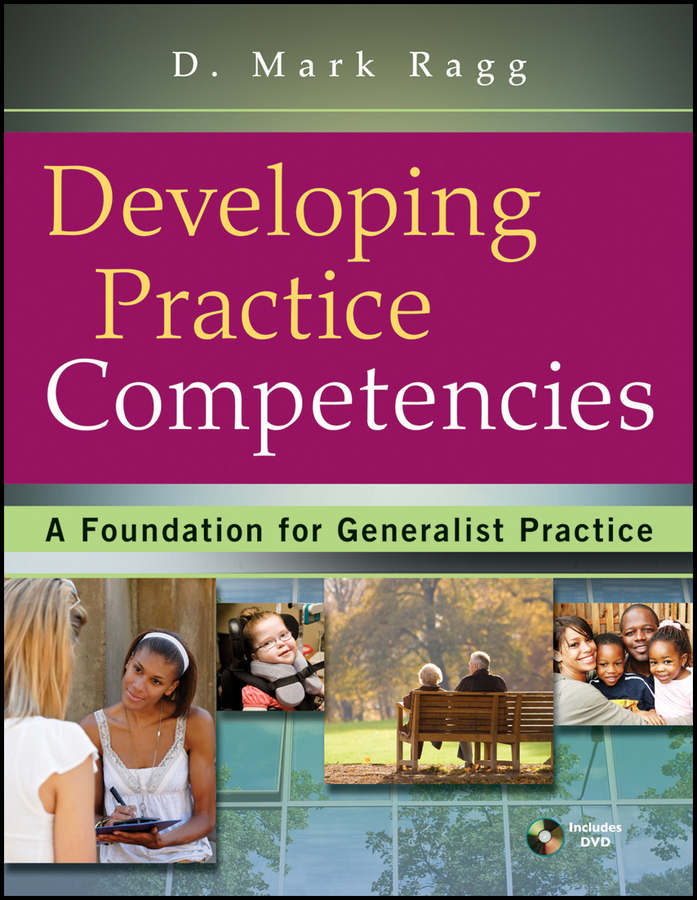
Developing Practice Competencies Praise for Developing Practice Competencies A Foundation for Generalist Practice "This is the textbook I have been waiting for. The author engages the reader from the very beginning. It includes comprehensive coverage of EPAS standards and practice behaviors that any social work instructor would be delighted with. Mark Ragg's explanation of social work concepts and practice skills is very readable and well illustrated. This textbook will enhance social work students' self-confidence in their skills as beginning practitioners. This is an author who clearly knows how to engage and excite social work students about contemporary social work. Strongly recommended for generalist practice programs!" —Mary Fran Davis, LCSW Austin Peay State University, Clarksville, Tennessee An applied, experiential introduction for the development of generalist practice skills in the helping professions Designed to help students in social work and human services programs establish a solid skill foundation for professional practice, Developing Practice Competencies holistically organizes this content knowledge through a consistent framework integrated throughout the book. Developing Practice Competencies explores: How to build on current interpersonal skills to develop a professional identity and a specialized repertoire of intervention skills How to work competently with diverse client groups taking into account the cultural and social contexts of each client situation Ways to engage individuals and larger client systems in focused work toward client-specific goals Successfully managing the nuances and challenges of the helping relationship Combining specific skills for use in evidence-based models Filled with rich examples, role-plays, and exercises, Developing Practice Competencies covers the foundation competencies necessary for students preparing to work with individuals, families, groups, organizations, and communities on behalf of underserved and socially compromised people. An accompanying DVD offers video of the practice skills in action and electronic versions of exercises for classroom discussions. POLITICAL SCIENCE,Public Policy,Social Services & Welfare

Enforcing Normalcy In this highly original study of the cultural assumptions governing our conception of people with disabilities, Lennard J. Davis argues forcefully against “ableist” discourse and for a complete recasting of the category of disability itself. Enforcing Normalcy surveys the emergence of a cluster of concepts around the term “normal” as these matured in western Europe and the United States over the past 250 years. Linking such notions to the concurrent emergence of discourses about the nation, Davis shows how the modern nation-state constructed its identity on the backs not only of colonized subjects, but of its physically disabled minority. In a fascinating chapter on contemporary cultural theory, Davis explores the pitfalls of privileging the figure of sight in conceptualizing the nature of textuality. And in a treatment of nudes and fragmented bodies in Western art, he shows how the ideal of physical wholeness is both demanded and denied in the classical aesthetics of representation. Enforcing Normalcy redraws the boundaries of political and cultural discourse. By insisting that disability be added to the familiar triad of race, class and gender, the book challenges progressives to expand the limits of their thinking about human oppression. POLITICAL SCIENCE,Public Policy,Social Services & Welfare
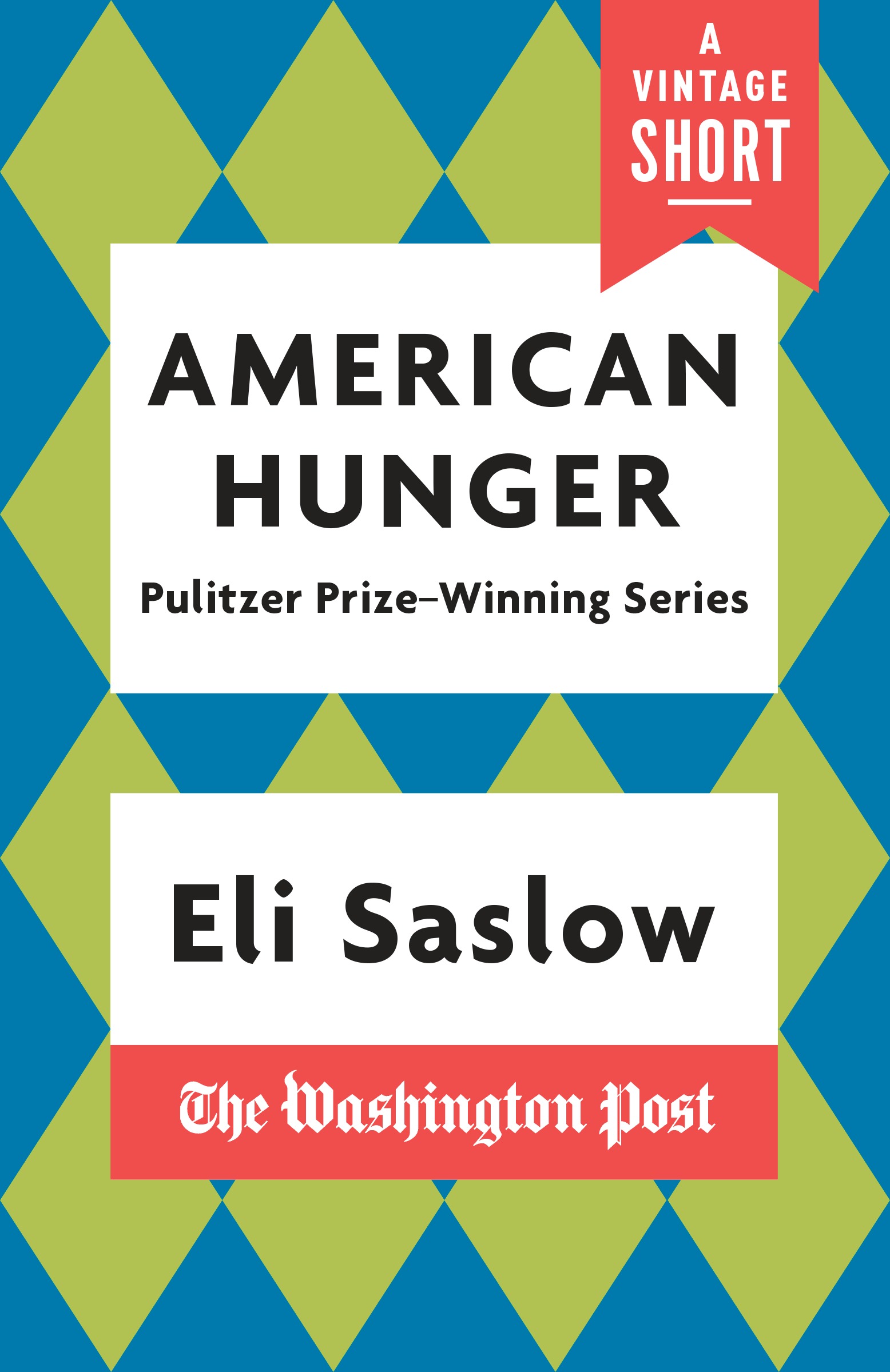
American Hunger Winner of the Pulitzer Prize for Explanatory Reporting In this Pulitzer Prize-winning collection, Washington Post reporter Eli Saslow traveled across the country over the course of a year—from Florida and Texas to Rhode Island and Tennessee—to examine the personal and political implications and repercussions of America's growing food stamp program. Saslow shows us the extraordinary impact the arrival of food stamps has each month on a small town's struggling economy, the difficult choices our representatives face in implementing this $78-billion program affecting millions of Americans, and the challenges American families, senior citizens, and children encounter every day in ensuring they have enough, and sometimes even anything to eat. These unsettling and eye-opening stories make for required reading, providing nuance and understanding to the complex matters of American poverty. An eBook short. POLITICAL SCIENCE,Public Policy,Social Services & Welfare
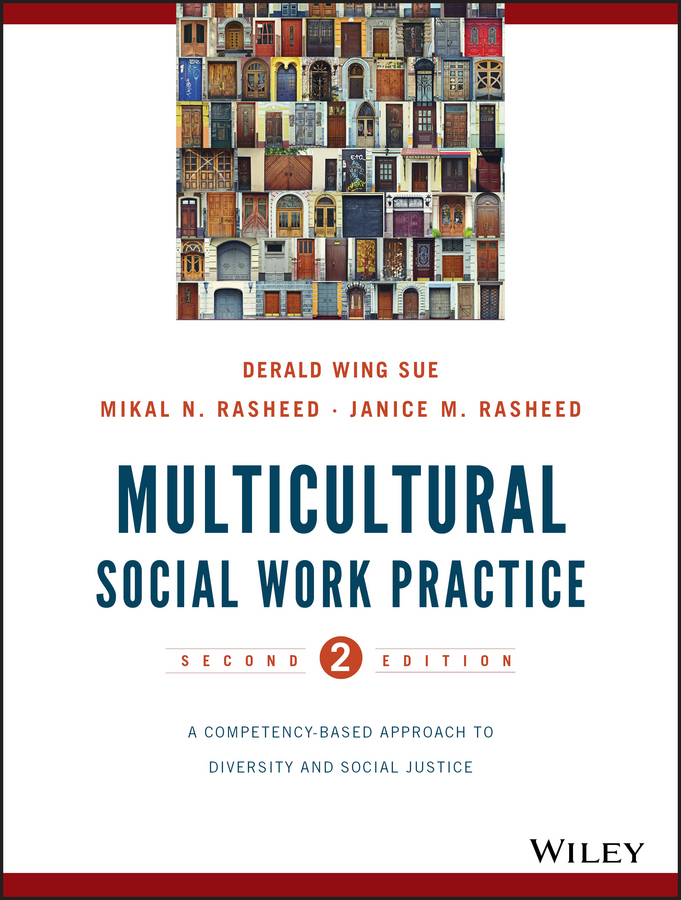
Multicultural Social Work Practice A thorough exploration of diversity and social justice within the field of social work Multicultural Social Work Practice: A Competency-Based Approach to Diversity and Social Justice, 2nd Edition has been aligned with the Council on Social Work Education's 2015 Educational Policy and Standards and incorporates the National Association of Social Workers Standards of Cultural Competence. New chapters focus on theoretical perspectives of critical race theory, microaggressions and changing societal attitudes, and evidence-based practice on research-supported approaches for understanding the influence of cultural differences on the social work practice. The second edition includes an expanded discussion of religion and spirituality and addresses emerging issues affecting diverse populations, such as women in the military. Additionally, Implications for Multicultural Social Work Practice' at the end of each chapter assist you in applying the information you have learned. Multicultural Social Work Practice, 2nd Edition provides access to important guidance regarding culturally sensitive social work practice, including the sociopolitical and social justice aspects of effective work in this field. This thoroughly revised edition incorporates new content and pedagogical features, including: Theoretical frameworks for multicultural social work practice Microaggressions in social work practice Evidence-based multicultural social work practice New chapter overviews, learning objectives, and reflection questions Multicultural Social Work Practice, 2nd Edition is an integral guide for students and aspiring social workers who want to engage in diversity and difference. POLITICAL SCIENCE,Public Policy,Social Services & Welfare
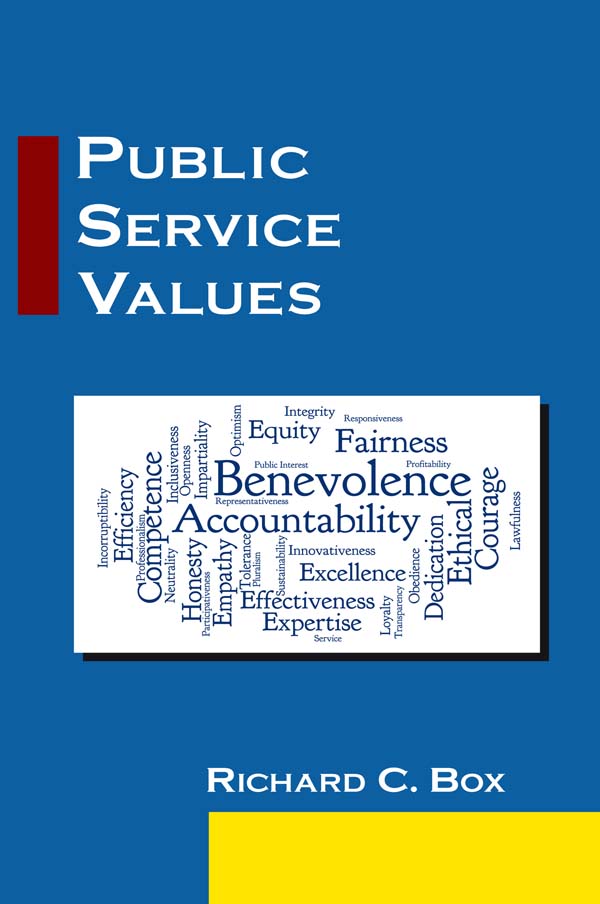
Public Service Values Public service values are too rarely discussed in public administration courses and scholarship, despite recent research demonstrating the importance of these values in the daily decision making processes of public service professionals. A discussion of these very tenets and their relevance to core public functions, as well as which areas might elicit value conflicts for public professionals, is central to any comprehensive understanding of budget and finance, human resource management, and strategic planning in the public sector. Public Service Values is written specifically for graduate and undergraduate courses in public administration, wherever a discussion of public service ideals might enrich the learning experience and offer students a better understanding of daily practice. Exploring the meaning and application of specific values, such as Neutrality, Efficiency, Accountability, Public Service, and Public Interest, provides students and future professionals with a ‘workplace toolkit’ for the ethical delivery of public services. Well-grounded in scholarly literature and with a relentless focus on the public service professional, Public Service Values highlights the importance of values in professional life and encourages a more self-aware and reflective public practice. Case studies to stimulate reflection are interwoven throughout the book and application to practice is cemented in a final section devoted to value themes in professional life as well as a chapter dedicated to holding oneself accountable. The result is a book that challenges us to embrace the necessity of public service values in our public affairs curricula and that asks the important questions current public service professionals should make a habit of routinely applying in their daily decision making. POLITICAL SCIENCE,Public Policy,Social Services & Welfare

Social Work and Disability Social Work and Disability offers a contemporary and critical exploration of social work practice with people with physical and sensory impairments, an area that has previously been marginalized within both practice and academic literature. It explores how social work practice can, and indeed does, contribute to the promotion of disabled people’s rights and the securing of positive outcomes in their lives. The book begins by exploring the ways in which disability is understood and how this informs policy and practice. Opening with a thought-provoking account of the lived experience of a disabled person using social work services, it goes on to critically analyse theory, policy and contemporary legislative change. Inequality, oppression and diversity are the focus of the second section of the book, while the remainder offers an in-depth exploration of the social work practice issues in disability settings, notably work with children, adults and safeguarding. Service-user and carer perspectives, case profiles, reflective activities and suggestions for further reading are included throughout. Social Work and Disability will be essential reading for social work students and practitioners. It will also be of interest to service users and carers, students on health and social care courses, third-sector practitioners and advocates. POLITICAL SCIENCE,Public Policy,Social Services & Welfare
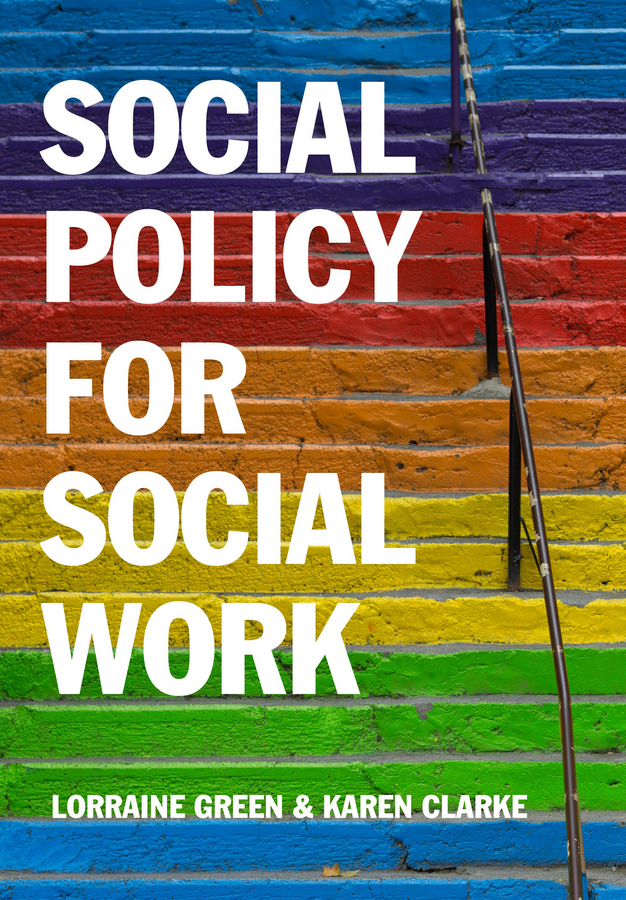
Social Policy for Social Work Contemporary social work cannot be understood without an appreciation of the broader context of social policy in which it takes place. Such an understanding is increasingly important as social workers are expected to work across institutional, professional and even national boundaries in new ways profoundly affected by the changing global context. This insightful book examines how shifts in the dominant political ideology have affected the nature of welfare provision, the kinds of social problems addressed by policy, and the balance of responsibilities for well-being between individuals, the family, voluntary organizations, the market and the state. It explains the impact of these developments on the organization of social work and on relationships between social workers and service users. The book discusses contested concepts central to social work – such as justice, liberty, equality, difference, need and risk – and illustrates these through a range of examples. The critical analysis provided in this book offers students of social work a crucial foundation for negotiating difficult and sensitive practice situations and defending their profession, providing them with the tools and knowledge to uphold key professional values. POLITICAL SCIENCE,Public Policy,Social Services & Welfare
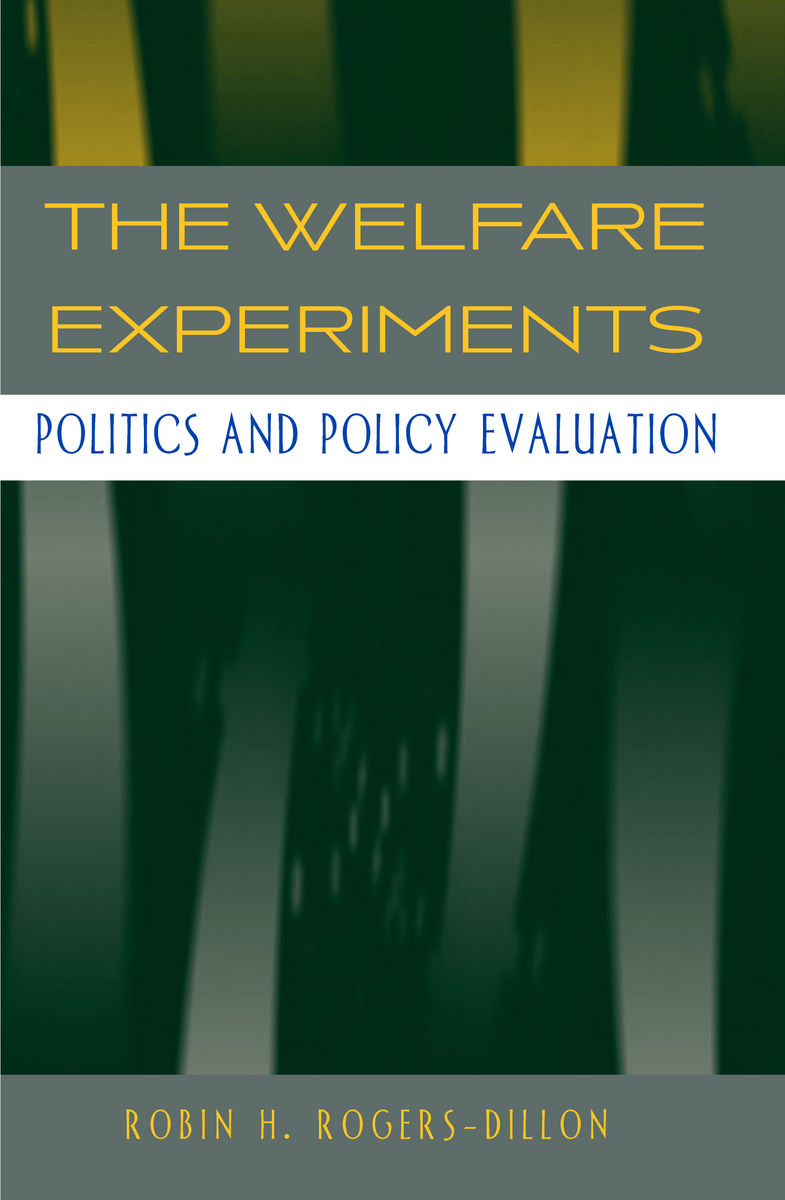
The Welfare Experiments In this book, Rogers-Dillon argues that these welfare experiments of the 1990s were not simply scientific experiments, as their supporters frequently contend, but a powerful political tool that created a framework within which few could argue successfully against the welfare policy changes. POLITICAL SCIENCE,Public Policy,Social Services & Welfare
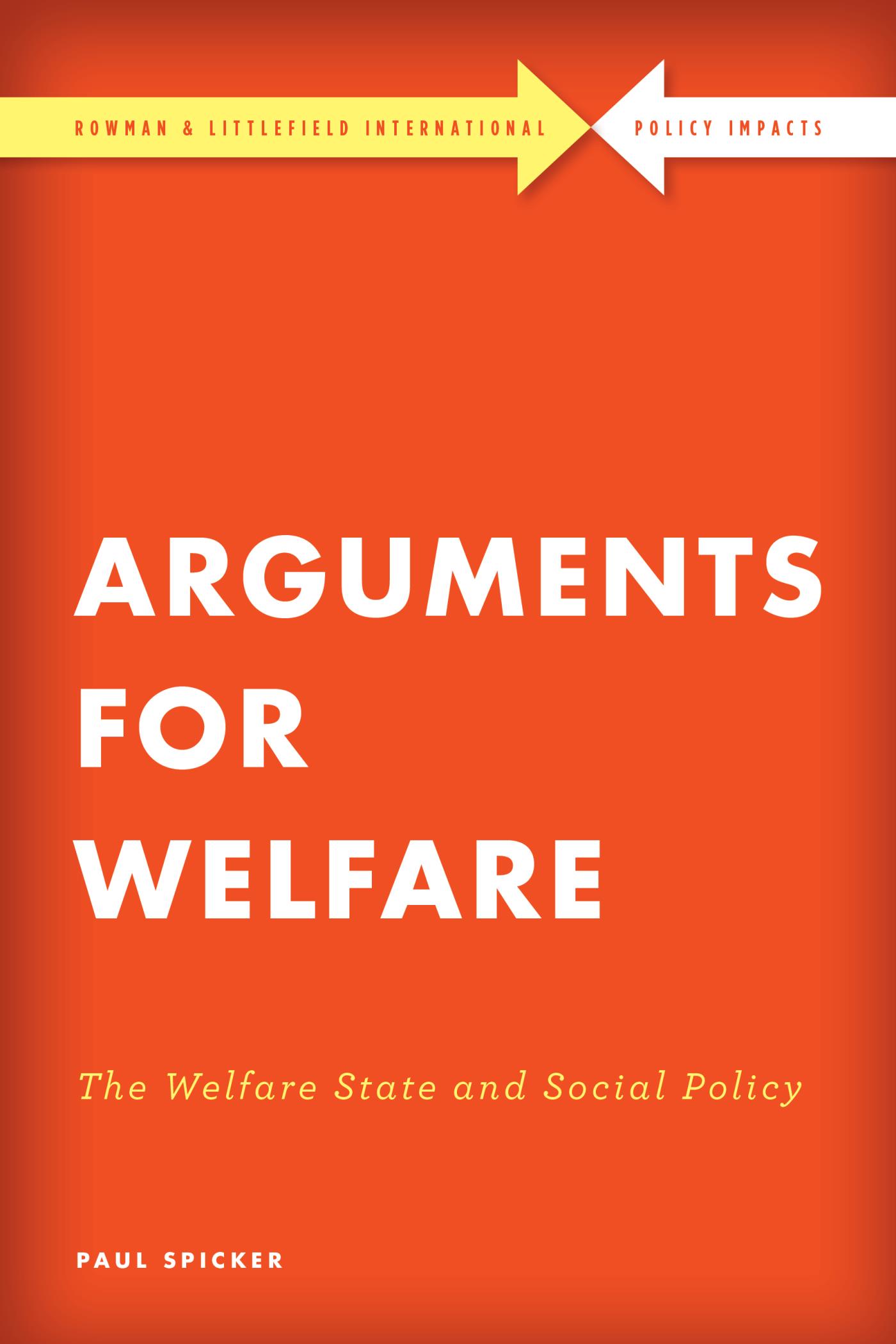
Arguments for Welfare This book is a concise explanation of what welfare is, and why it is important. With examples from the UK, Europe, North America and Australia the book explores how the principles of welfare are applied across the world. POLITICAL SCIENCE,Public Policy,Social Services & Welfare

Welfare in an Idle Society? The modern welfare state is indeed one of the greatest achievements of the post-war 20th century. With its key aims of eradicating the five giant social ills of Want, Ignorance, Disease, Squalor and Idleness, it aimed to providing a minimum standard of living, with all people of working age paying a weekly contribution; in return, benefits would be paid to anyone who was sick, unemployed, retired or widowed. The modern welfare state, therefore, is about maintaining a delicate equilibrium between dependent social groups on the one hand and the active working classes on the other. In the case of old-age security, this balance is being achieved (or not) by the so-called Generation Contract. This social pact is more of an implicit, unwritten and unspecified social contract. This ground-breaking book demonstrates how countries are addressing population-ageing challenges in depth, using the case study of Austria to gain the required complexity and differentiation in a comparative European framework of empirical evidence. This is a broad social science study in political economy and sociology, not an economic analysis. Though focusing on pensions, it centres on the (im)balance between work and non-work, issues of health, work ability, employability, and benefit receipt from old-age security to disability allowance. It will be required reading for all sociologists and social policy experts and academics working within this area. POLITICAL SCIENCE,Public Policy,Social Services & Welfare
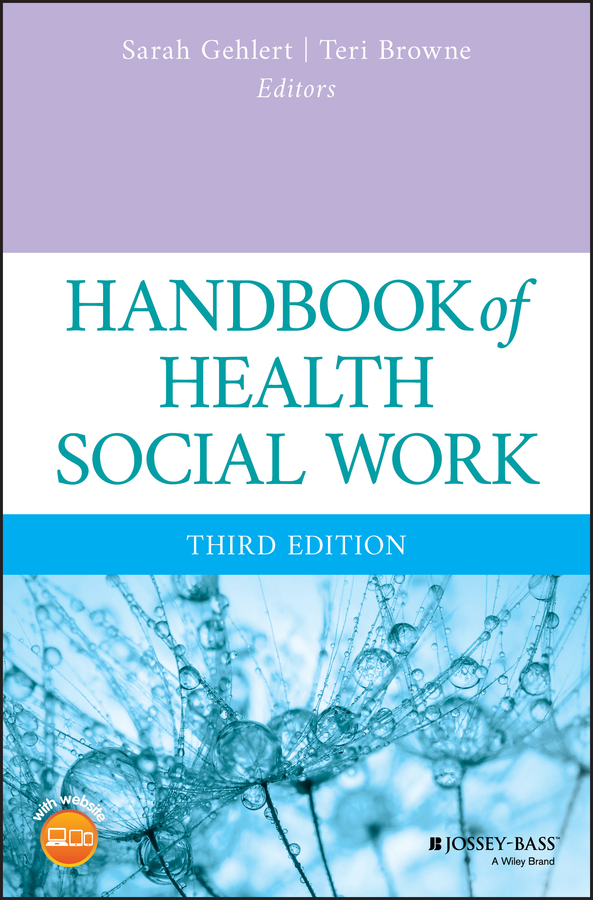
Handbook of Health Social Work The updated third edition of the definitive text on health social work Thoroughly revised and updated, the third edition of Handbook of Health Social Work is an authoritative text that offers a comprehensive review of the diverse field of health social work. With contributions from a panel of international experts in the field, the book is theory driven and solidly grounded in evidence-based practice. The contributors explore both the foundation of social work practice and offer guidance on effective strategies, policies, and program development. The text provides information that is essential to the operations of social workers in health care including the conceptual underpinnings and the development of the profession. The authors explore the practice issues such as theories of health behavior, assessment, communication and the intersections between health and mental health. The authors also examine a wide range of examples of social work practices including settings that involve older adults, nephrology, oncology, and chronic diseases such as diabetes, heart disease, HIV/AIDS, genetics, end of life care, pain management and palliative care, as well as alternative treatments, and traditional healers. This is the only handbook of its kind to unite the body of health social work and: • Offers a wellness, rather than psychopathological perspective and contains treatment models that are evidence-based • Includes learning exercises, further resources, research suggestions, and life-course information. • Contains new chapters on topics such as international health, insurance and payment systems, and implementation of evidence-based practice • Presents information on emerging topics such as health policy in an age of reform, and genomics and the social environment • Reviews new trends in social work and health care including genetics, trans-disciplinary care, and international, national, and state changes in policy Written for social work educators, administrators, students, and practitioners, the revised third edition of Handbook of Health Social Work offers in one volume the entire body of health social work knowledge. POLITICAL SCIENCE,Public Policy,Social Services & Welfare
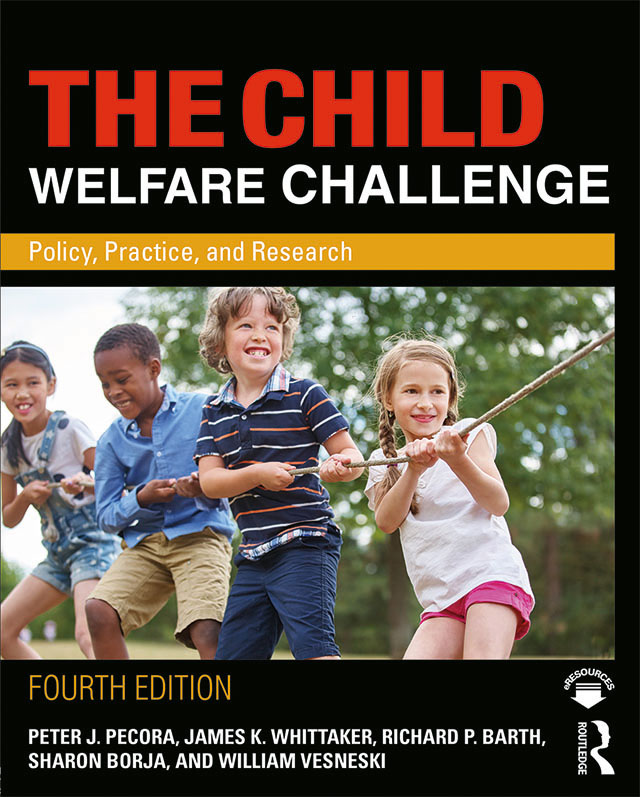
The Child Welfare Challenge Using both historical and contemporary contexts, The Child Welfare Challenge examines major policy practice and research issues as they jointly shape child welfare practice and its future. This text focuses on families and children whose primary recourse to services has been through publicly funded child welfare agencies, and considers historical areas of service—foster care and adoptions, in-home family-centered services, child-protective services, and residential treatment services—where social work has an important role. This fourth edition features new content on child maltreatment and prevention that is informed by key conceptual frameworks informed by brain science, public health, and other research. This edition uses cross-sector data and more sophisticated predictive and other analytical processes to enhance planning and practice design. The authors have streamlined content on child protective services (CPS) to allow for new chapters on juvenile justice/cross-over youth, and international innovations, as well as more content on biology and brain science. The fourth edition includes a glossary of terms as well as instructor and student resource papers available online. POLITICAL SCIENCE,Public Policy,Social Services & Welfare
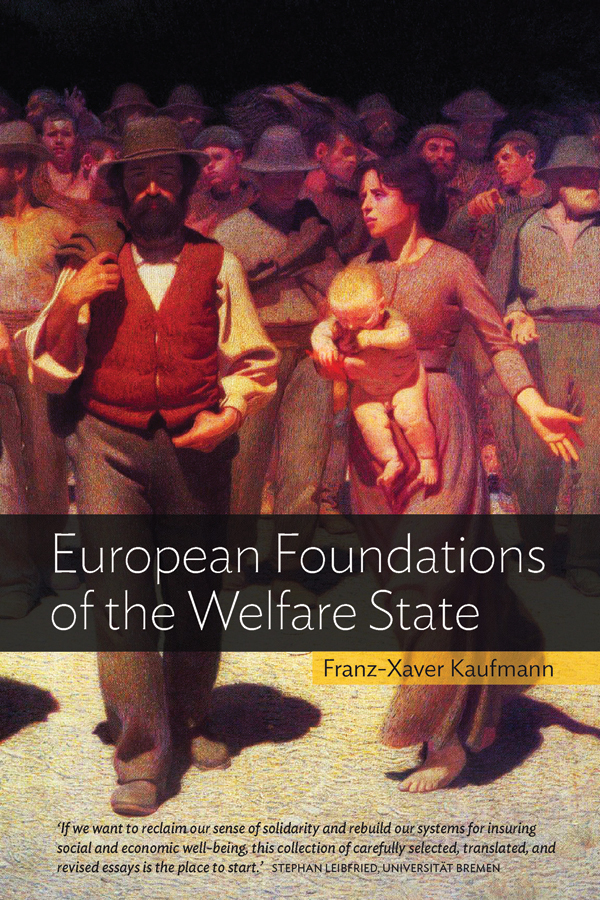
European Foundations of the Welfare State While social welfare programs, often inspired by international organizations, are spreading throughout the world, the more far-reaching notion of governmental responsibility for the basic well-being of all members of a political society is not, although it remains a feature of Europe and the former British Commonwealth. The welfare state in the European sense is not simply an administrative arrangement of various measures of social protection but a political project embedded in distinct cultural traditions. Offering the first accessible account in English of the historical development of the European idea of the welfare state, this book reviews the intellectual foundations which underpinned the road towards the European welfare state, formulates some basic concepts for its understanding, and highlights the differences in the underlying structural and philosophical conditions between continental Europe and the English-speaking world. POLITICAL SCIENCE,Public Policy,Social Services & Welfare
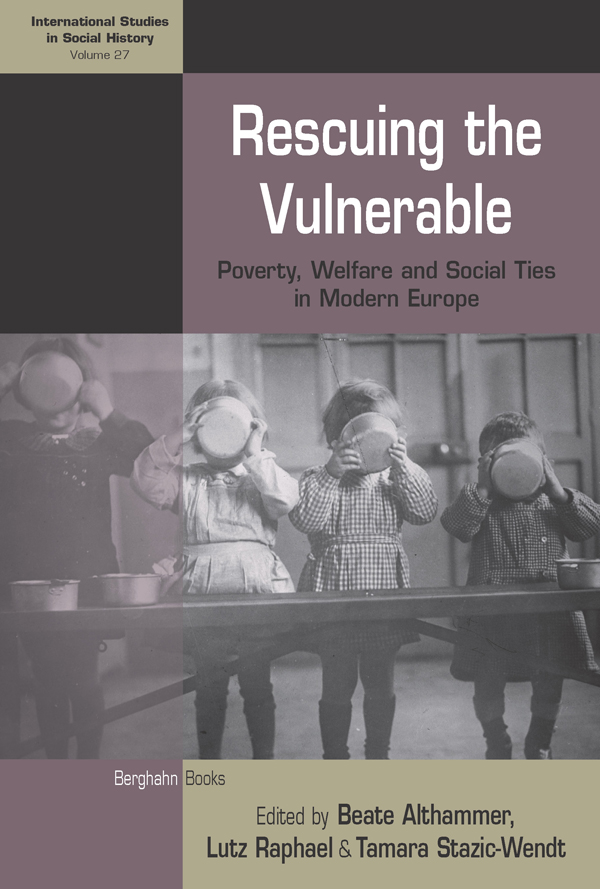
Rescuing the Vulnerable In many ways, the European welfare state constituted a response to the new forms of social fracture and economic turbulence that were born out of industrialization—challenges that were particularly acute for groups whose integration into society seemed the most tenuous. Covering a range of national cases, this volume explores the relationship of weak social ties to poverty and how ideas about this relationship informed welfare policies in the nineteenth and twentieth centuries. By focusing on three representative populations—neglected children, the homeless, and the unemployed—it provides a rich, comparative consideration of the shifting perceptions, representations, and lived experiences of social vulnerability in modern Europe. POLITICAL SCIENCE,Public Policy,Social Services & Welfare

Philanthropy Under Fire In Philanthropy Under Fire, author Howard Husock defends the American tradition of independent philanthropy from significant political and intellectual challenges which threaten it today. Although the U.S. continues to be the most charitable nation in the world, serious efforts seek to discourage traditional, personal charitable giving by changing the tax code, and directing philanthropy toward causes chosen by government. Some voices seek to narrow the very definition of philanthropy to include only direct redistribution of income from rich to poor. In contrast, Mr. Husock broadly defends philanthropy’s causesfrom the food pantry to the art museum to the university science labas both a source of effective new ideas and as a core aspect of democracy and liberty. In a new and original argument, he asserts that having broad impact does not require a marriage of philanthropy and government. Instead, he says, private programs growing out of the values held by their leadersand imbued with those valuescan have a wide impact through their influence on society’s norms. In this sense, the good that private philanthropy does for American society can far transcend the good that it does for its immediate recipients. POLITICAL SCIENCE,Public Policy,Social Services & Welfare

Stretched Thin Stretched Thin looks back at a critical moment of policy change and suggests how welfare policy in the United States can be changed to better address the needs of poor families and the nation, question the claim that welfare reform has been a success. POLITICAL SCIENCE,Public Policy,Social Services & Welfare

Teeth An NPR Best Book of 2017 "[Teeth is] . . . more than an exploration of a two-tiered system—it is a call for sweeping, radical change." New York Times Book Review “Show me your teeth,†the great naturalist Georges Cuvier is credited with saying, “and I will tell you who you are.†In this shattering new work, veteran health journalist Mary Otto looks inside America’s mouth, revealing unsettling truths about our unequal society. Teeth takes readers on a disturbing journey into America’s silent epidemic of oral disease, exposing the hidden connections between tooth decay and stunted job prospects, low educational achievement, social mobility, and the troubling state of our public health. Otto’s subjects include the pioneering dentist who made Shirley Temple and Judy Garland’s teeth sparkle on the silver screen and helped create the all-American image of “pearly whitesâ€; Deamonte Driver, the young Maryland boy whose tragic death from an abscessed tooth sparked congressional hearings; and a marketing guru who offers advice to dentists on how to push new and expensive treatments and how to keep Medicaid patients at bay. In one of its most disturbing findings, Teeth reveals that toothaches are not an occasional inconvenience, but rather a chronic reality for millions of people, including disproportionate numbers of the elderly and people of color. Many people, Otto reveals, resort to prayer to counteract the uniquely devastating effects of dental pain. Otto also goes back in time to understand the roots of our predicament in the history of dentistry, showing how it became separated from mainstream medicine, despite a century of growing evidence that oral health and general bodily health are closely related. Muckraking and paradigm-shifting, Teeth exposes for the first time the extent and meaning of our oral health crisis. It joins the small shelf of books that change the way we view society and ourselves—and will spark an urgent conversation about why our teeth matter. POLITICAL SCIENCE,Public Policy,Social Services & Welfare

Social Housing in the Middle East 1. This timely book traces the history of social housing in the Middle East and considers how culture, faith, and politics influence the housing solutions offered. Social housing has far reaching affects on areas such as security, health, and political stability in a community. 2. This collection provides a provocative consideration of urban living spaces which are overlooked at best and threatened at worst. This is a neglected field of research in a topic which has global impact. 3. It provides fresh insight into national security and community building through the surprising lens of architecture using 85 beautiful images, which illustrate how social housing engages with the communities. POLITICAL SCIENCE,Public Policy,Social Services & Welfare

Psychology And Social Policy This work explores the application of psychological data and theories to controversial policy issues such as racial and gender inequality, violence and criminal justice. The book also asks whether psychology really has relevant expertise to contribute. First published in 1992. Routledge is an imprint of Taylor & Francis, an informa company. POLITICAL SCIENCE,Public Policy,Social Services & Welfare
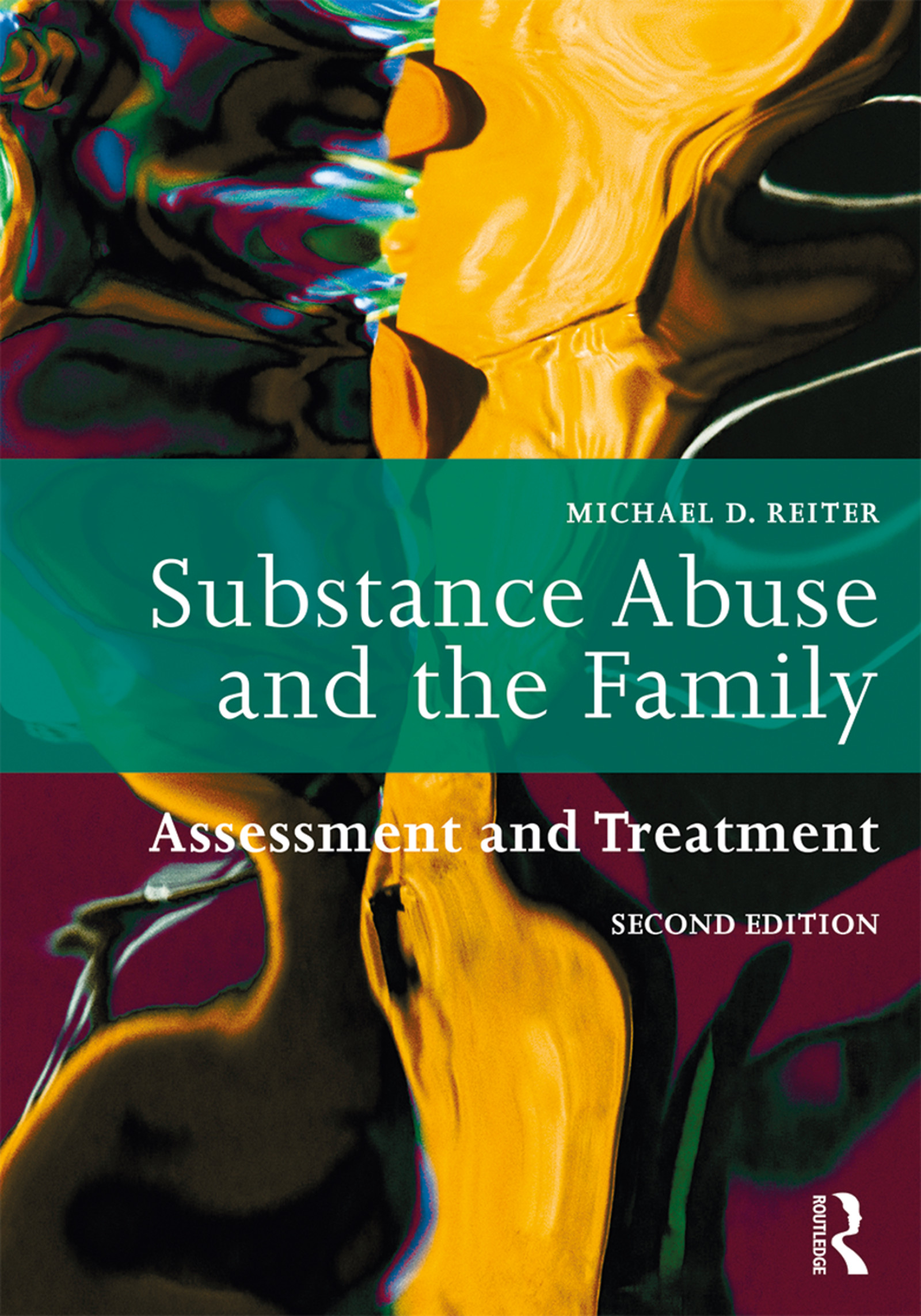
Substance Abuse and the Family In this updated edition of Substance Abuse and the Family, Michael D. Reiter examines addiction through a family systems lens which considers a range of interconnected contexts, such as biology and genetics, family relationships, and larger systems. Chapters are organized around two sections: Assessment and Treatment. Examining how the family system organizes around substance use and abuse, the first section includes contributions on the neurobiology and genetics of addiction, as well as chapters on family diversity, issues in substance-using families, and working in a culturally sensitive way. The second half of the book explores various treatment options for individuals and families presenting with substance abuse issues, providing an overview of the major family therapy theories, and chapters on self-help groups and the process of family recovery. The second edition has many useful additions including a revision of the family diversity chapter to consider sexual and gender minorities, brand new chapters on behavioral addictions such as sex and gambling, and a chapter on ethical implications in substance abuse work with families. Additional sections include information on Multisystemic Therapy, Behavioral Couples Therapy, Motivational Interviewing, and Twelve-Step Facilitation. Each chapter now contains a case application to help demonstrate treatment strategies in practice. Intended for undergraduate and graduate students, as well as beginning practitioners, Substance Abuse and the Family, 2nd Ed. remains one of the most penetrating and in-depth examinations on the topic available. POLITICAL SCIENCE,Public Policy,Social Services & Welfare
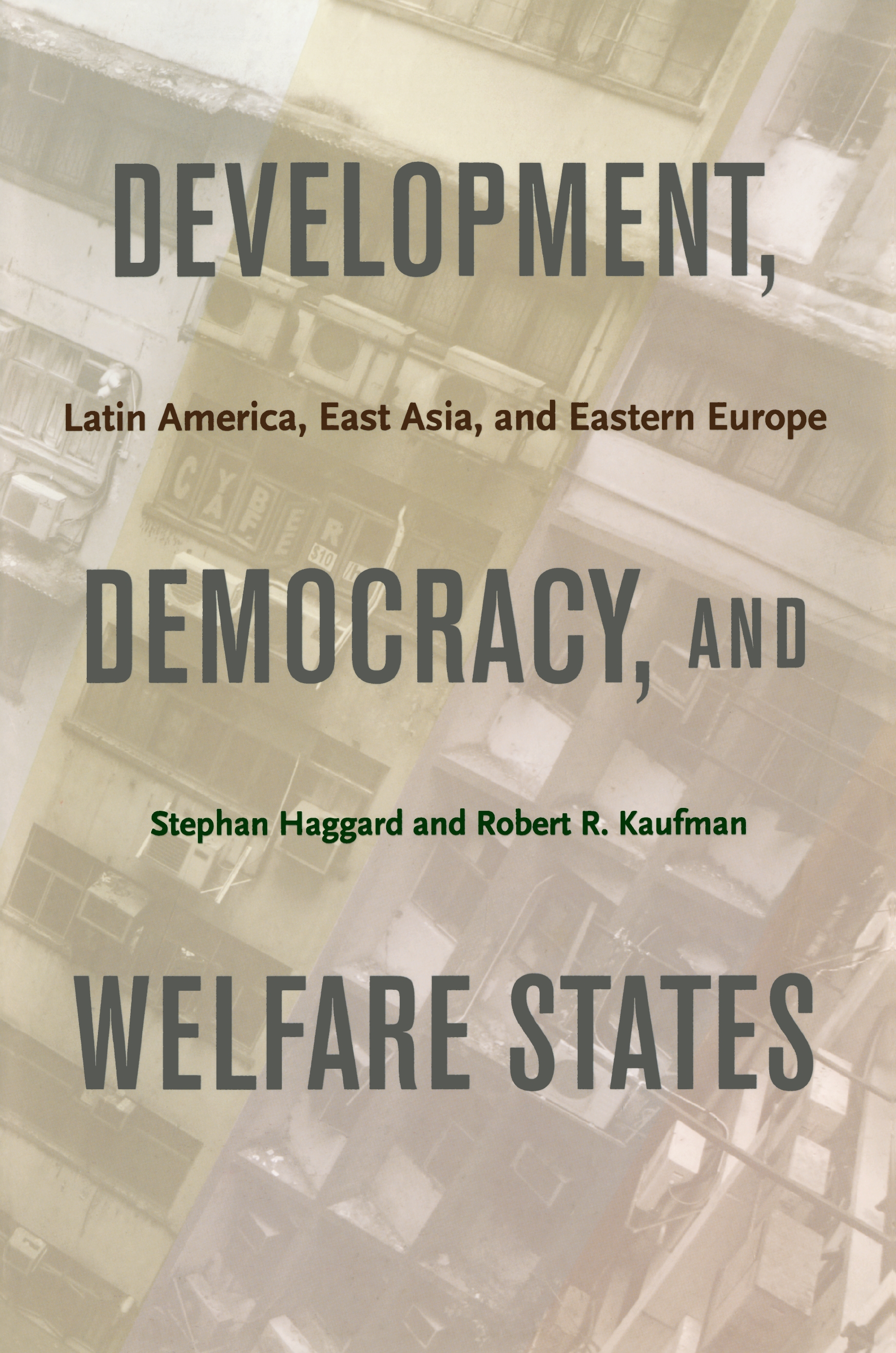
Development, Democracy, and Welfare States This is the first book to compare the distinctive welfare states of Latin America, East Asia, and Eastern Europe. Stephan Haggard and Robert Kaufman trace the historical origins of social policy in these regions to crucial political changes in the mid-twentieth century, and show how the legacies of these early choices are influencing welfare reform following democratization and globalization. After World War II, communist regimes in Eastern Europe adopted wide-ranging socialist entitlements while conservative dictatorships in East Asia sharply limited social security but invested in education. In Latin America, where welfare systems were instituted earlier, unequal social-security systems favored formal sector workers and the middle class. Haggard and Kaufman compare the different welfare paths of the countries in these regions following democratization and the move toward more open economies. Although these transformations generated pressure to reform existing welfare systems, economic performance and welfare legacies exerted a more profound influence. The authors show how exclusionary welfare systems and economic crisis in Latin America created incentives to adopt liberal social-policy reforms, while social entitlements from the communist era limited the scope of liberal reforms in the new democracies of Eastern Europe. In East Asia, high growth and permissive fiscal conditions provided opportunities to broaden social entitlements in the new democracies. This book highlights the importance of placing the contemporary effects of democratization and globalization into a broader historical context. POLITICAL SCIENCE,Public Policy,Social Services & Welfare
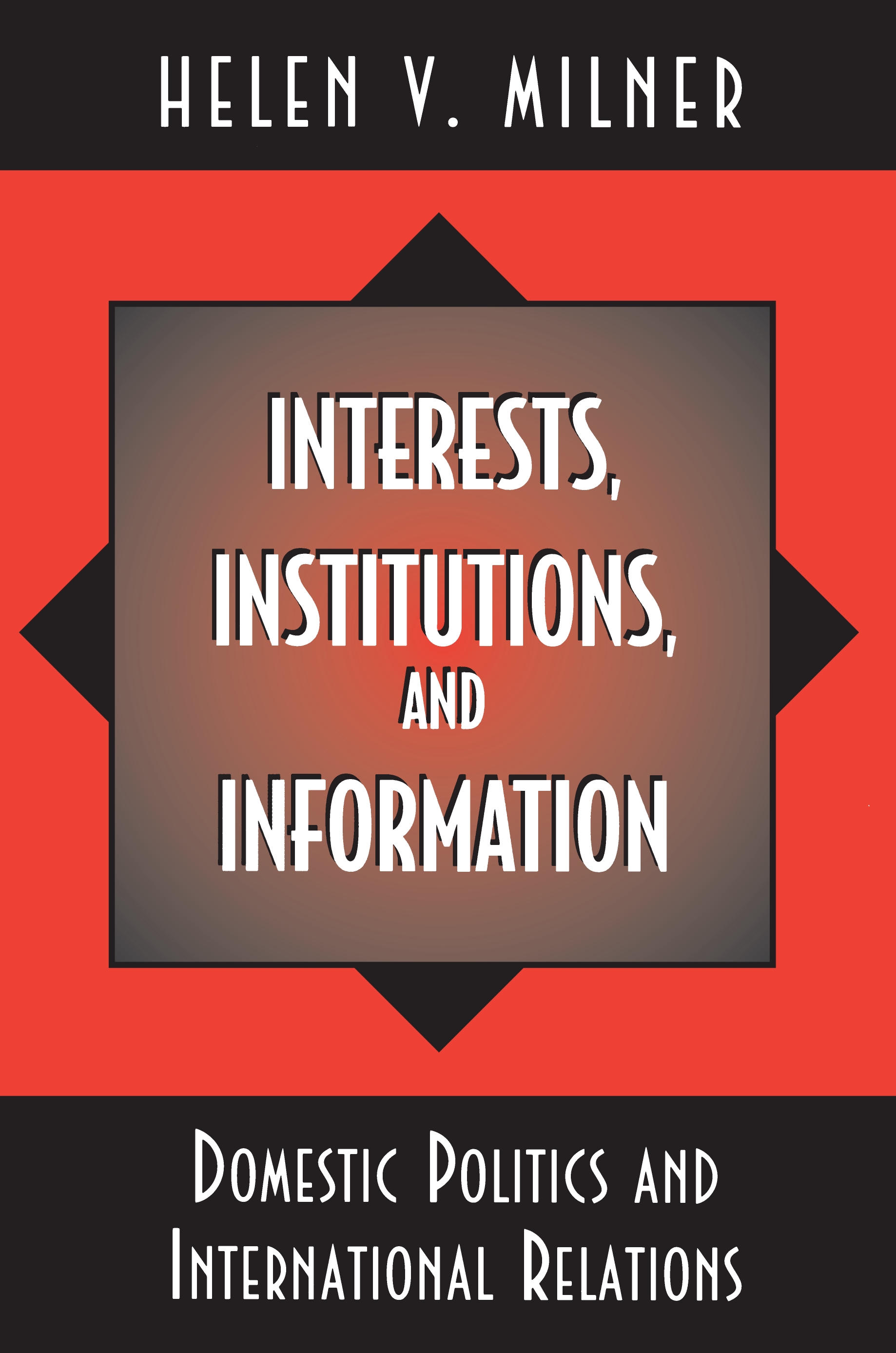
Interests, Institutions, and Information Increasingly scholars of international relations are rallying around the idea that "domestic politics matters." Few, however, have articulated precisely how or why it matters. In this significant book, Helen Milner lays out the first fully developed theory of domestic politics, showing exactly how domestic politics affects international outcomes. In developing this rational-choice theory, Milner argues that any explanation that treats states as unitary actors is ultimately misleading. She describes all states as polyarchic, where decision-making power is shared between two or more actors (such as a legislature and an executive). Milner constructs a new model based on two-level game theory, reflecting the political activity at both the domestic and international levels. She illustrates this model by taking up the critical question of cooperation among nations. Milner examines the central factors that influence the strategic game of domestic politics. She shows that it is the outcome of this internal game--not fears of other countries' relative gains or the likelihood of cheating--that ultimately shapes how the international game is played out and therefore the extent of cooperative endeavors. The interaction of the domestic actors' preferences, given their political institutions and levels of information, defines when international cooperation is possible and what its terms will be. Several test cases examine how this argument explains the phases of a cooperative attempt: the initiation, the negotiations at the international level, and the eventual domestic ratification. The book reaches the surprising conclusion that theorists--neo-Institutionalists and Realists alike--have overestimated the likelihood of cooperation among states. POLITICAL SCIENCE,Public Policy,Social Services & Welfare
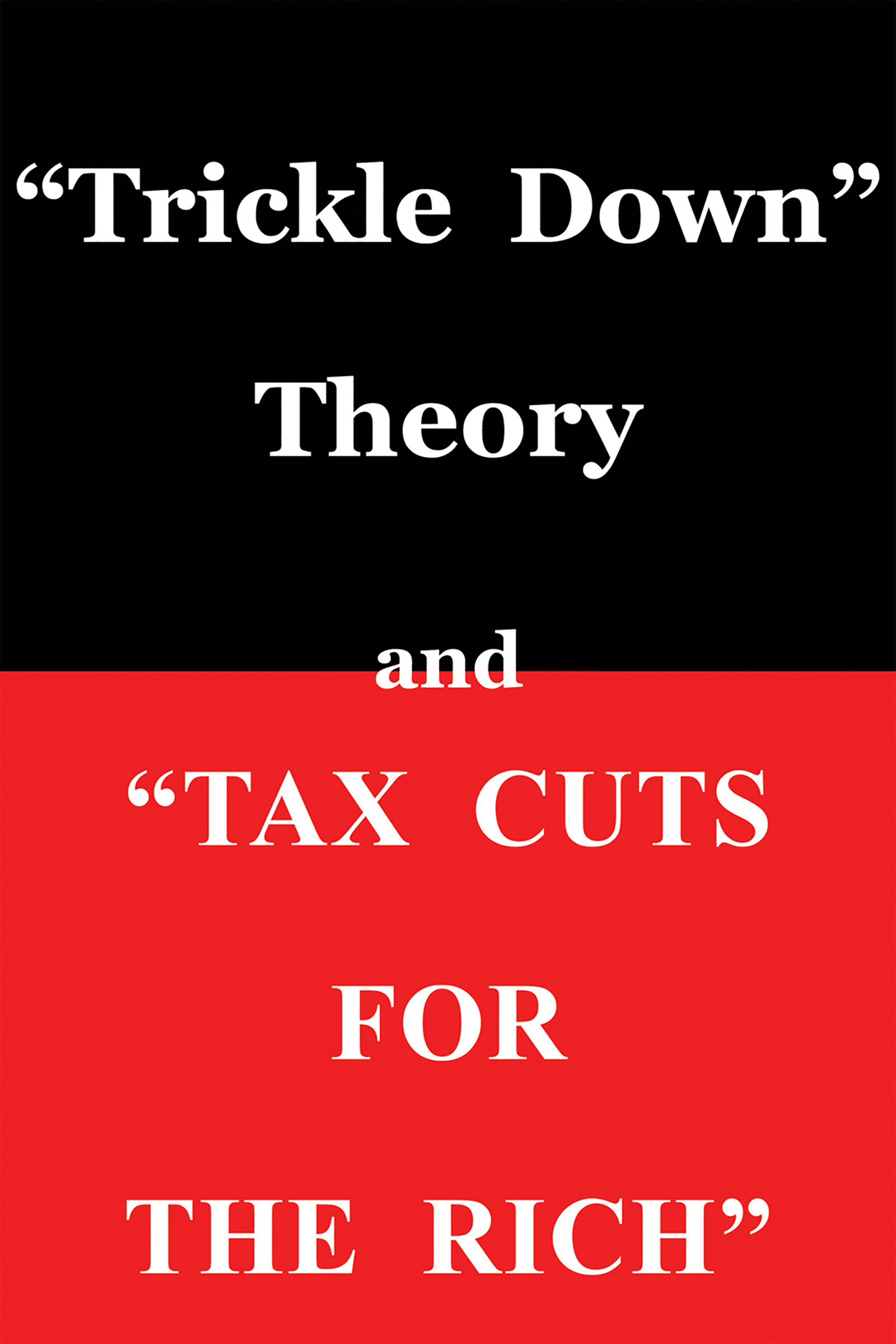
"Trickle Down Theory" and "Tax Cuts for the Rich" This essay unscrambles gross misconceptions that have made rational debates about tax policies virtually impossible for decades. POLITICAL SCIENCE,Reference
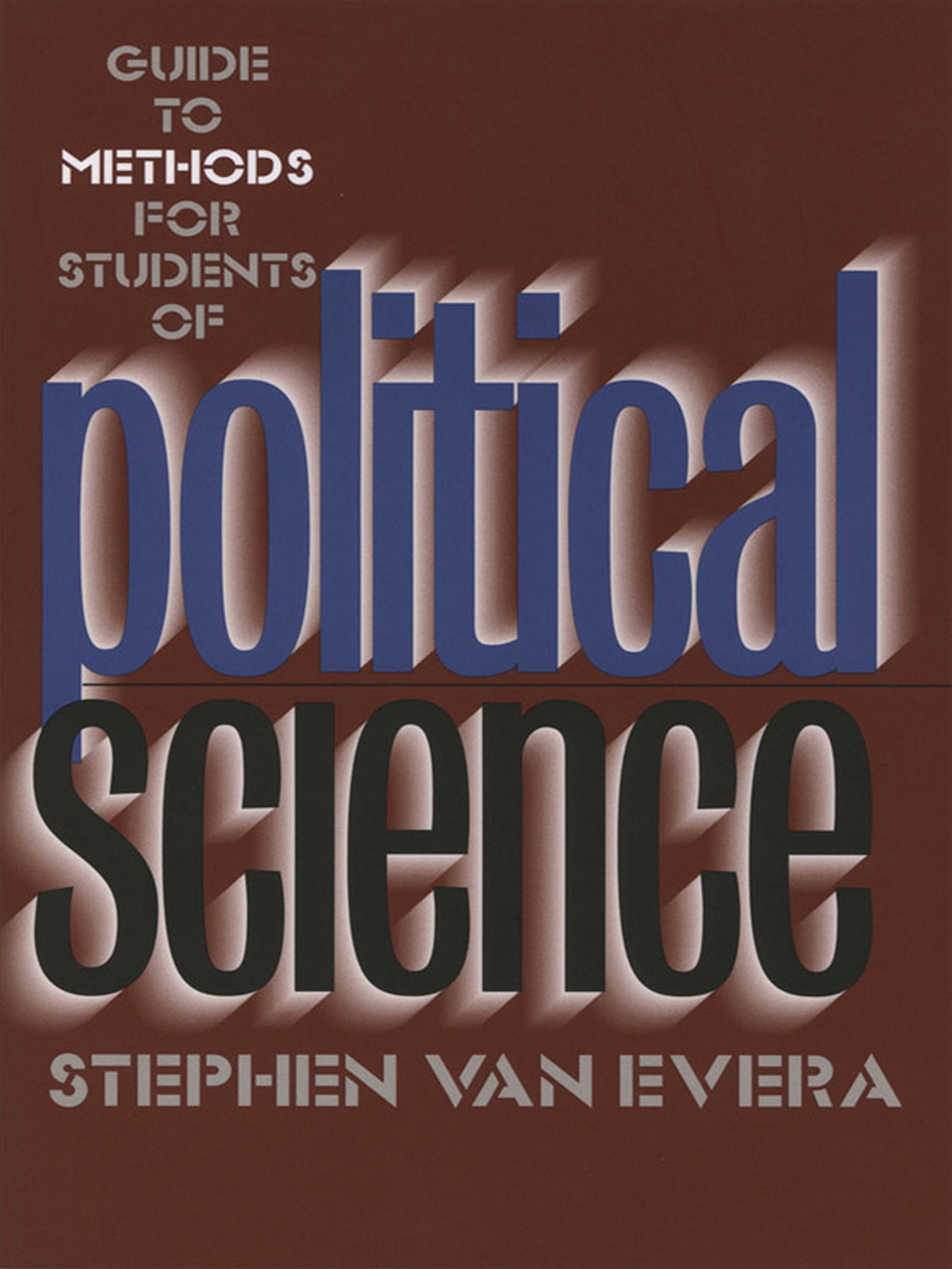
Guide to Methods for Students of Political Science "Stephen Van Evera's Guide to Methods makes an important contribution toward improving the use of case studies for theory development and testing in the social sciences. His trenchant and concise views on issues ranging from epistemology to specific... POLITICAL SCIENCE,Reference

The CIA World Factbook 2020-2021 From the world’s most sophisticated intelligence gathering organization, here is the CIA’s official country-by-country data on nations around the world. From Afghanistan to Zimbabwe, The CIA World Factbook 2020-2021 offers complete and up-to-date information on the world's nations. This comprehensive guide is packed with data on the politics, populations, military expenditures, and economics of 2020 and looks ahead to 2021. For each country, The CIA World Factbook 2020-2021 includes: Detailed maps with new geopolitical data Statistics on the population of each country, with details on literacy rates, HIV prevalence, and age structure New data on military expenditures and capabilities Information on each country's climate and natural hazards Details on prominent political parties and contact information for diplomatic consultation Facts on transportation and communication infrastructure Also included are appendixes with useful abbreviations, international environmental agreements, international organizations and groups, weight and measure conversions, and more. Originally intended for use by government officials, this is a must-have resource for students, travelers, journalists, and business people with a desire to know more about their world. POLITICAL SCIENCE,Reference
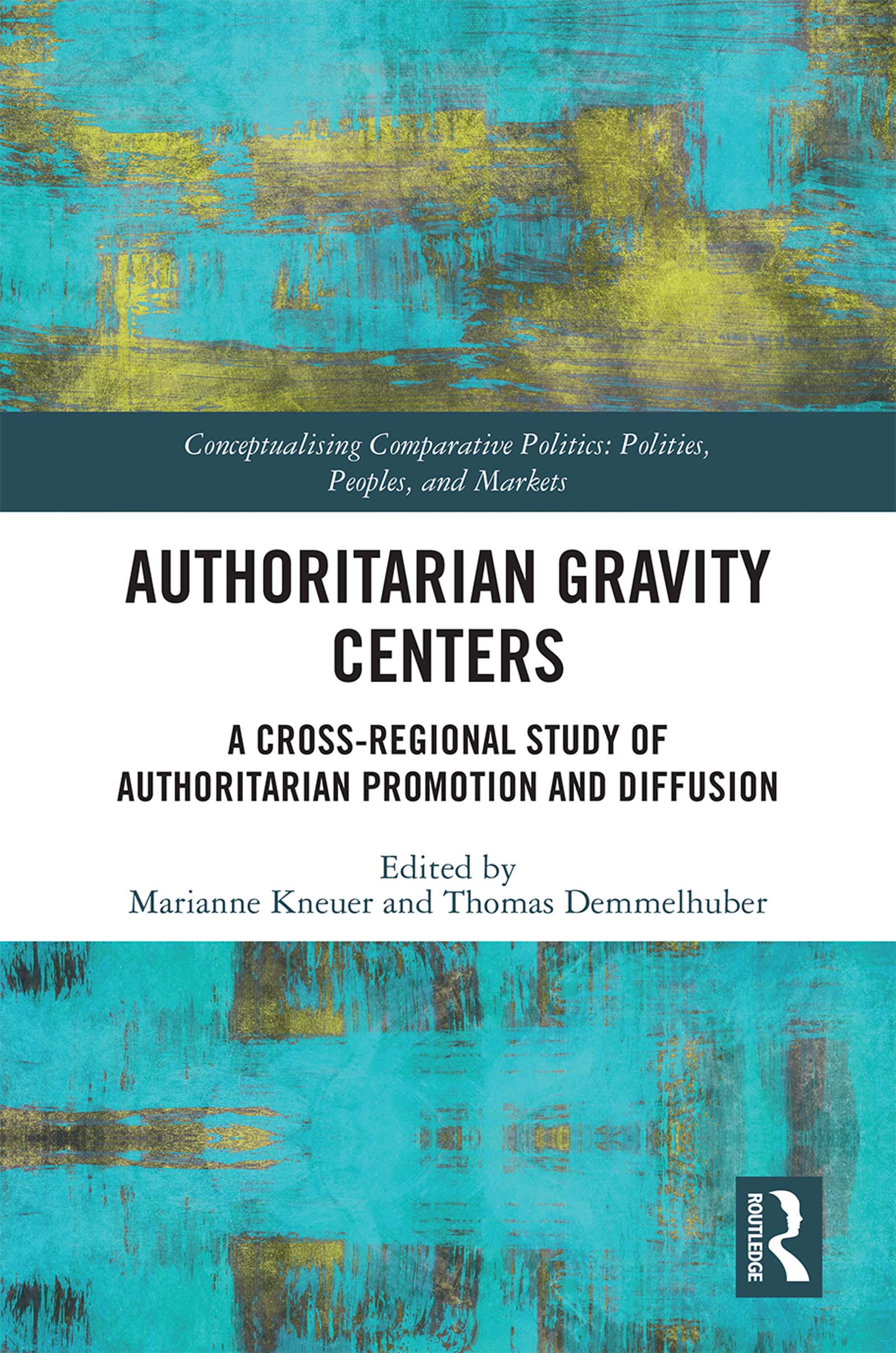
Authoritarian Gravity Centers Autocracies not only resist the global spread of democracy but are sources of autocratic influence and pressure. This book presents a conceptual model to understand, assess, and explain the promotion and diffusion of authoritarian elements. Employing a cross-regional approach, leading experts empirically test the concept of authoritarian gravity centers (AGCs), defined as "regimes that constitute a force of attraction and contagion for countries in geopolitical proximity." With an analysis extending across Latin America, the Middle East, Eastern Europe, Central Asia, and Asia, these AGCs are shown to be effective as active promoters (push) or as neutral sources of attraction (pull). The authors contend that the influence of exogenous factors, along with international and regional contexts for the transformation of regime types, is vital to understanding and analyzing the transmission of autocratic institutional settings, ideas, norms, procedures, and practices, thus explaining the regional clustering of autocracies. It is the regional context in which external actors can influence authoritarian processes most effectively. Authoritarian Gravity Centers is a vibrant and comprehensive contribution to the growing field of autocratization, which will be of great interest to undergraduate and postgraduate students of comparative area studies, illiberalism, international politics, and studies of democracy. POLITICAL SCIENCE,Reference

Transportation Security Insecure transportation systems are costing our worldwide mobility-based economy as much as 6% of GDP annually. The effectiveness of security measures vary widely. In the United States, depending on the mode of transportation, it ranges from “medium effectiveness for airports to “low effectiveness for maritime, rail, transit, and intermodal activities. Situational awareness and interoperability are lacking as we try to deal with both natural and man-made disasters. Regardless of the transport mode, improvements are essential if governments and corporations are to address security planning, response, and national preparedness. Transportation Security examines this problem in a comprehensive manner and addresses security-based technologies and solutions to minimize risk. * Covers air, sea, roadway, rail and public transport modes* Offers technological solutions for mobility based problems in planning, logistics and policy to improve security, combat terrorism and ensure national preparedness* Includes work of international experts & global examples related to transportation security POLITICAL SCIENCE,Security (National & International)

Learning to Forget This book studies the impact of the lessons and legacies of the Vietnam War on the formulation of US counterinsurgency doctrine in the postVietnam years, with particular reference to the interplay of the 'lessons of history' with doctrine. POLITICAL SCIENCE,Security (National & International)

Regional Organisations and Security This book aims to examine the conceptions and practices of security adopted by Regional Organisations (ROs) across the globe. Since the end of the Cold War, there has been an increased focus on regions as a relevant realm for security, with actors within regional contexts identifying a significant degree of interdependency between one another. As a consequence, international security has taken on a distinct regionally institutionalised character, as seen by the increase in calls for greater utilisation of ‘Chapter VIII: Regional Arrangements’ of the UN, in order to create a devolved UN-led system of global security management. However, the idea of a system of global security management is a remote prospect, because divergence seems to be as important as commonality in terms of regional security. In light of the above, Regional Organisations and Security analyses the primary ROs that are active in Africa, Asia, Eurasia, the Middle East and South America. The findings of individual case studies are compiled to highlight disparities and similarities in how security is seen, prioritised, understood, practised, managed and implemented across regions. On this basis, the authors reach conclusions about whether we live in an increasingly globalised or regionally distinct world, and go on to assess the prospects for a globalised system of security management and consider how this might be developed and organised. This book will be of interest to students of comparative regionalism, international organisations, international security and IR. POLITICAL SCIENCE,Security (National & International)
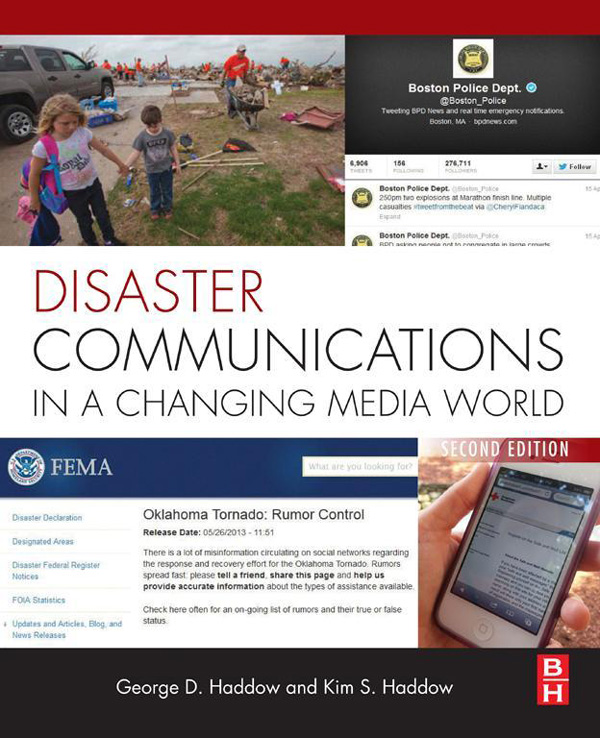
Disaster Communications in a Changing Media World Communications are key to the success of disaster mitigation, preparedness, response, and recovery. Accurate information disseminated to the general public, to elected officials and community leaders, as well as to the media, reduces risk, saves lives and property, and speeds recovery. Disaster Communications in a Changing Media World, Second Edition, provides valuable information for navigating these priorities in the age of evolving media. The emergence of new media like the Internet, email, blogs, text messaging, cell phone photos, and the increasing influence of first informers are redefining the roles of government and media. The tools and rules of communications are evolving, and disaster communications must also evolve to accommodate these changes and exploit the opportunities they provide. Disaster Communications in a Changing Media World, Second Edition, illuminates the path to effective disaster communication, including the need for transparency, increased accessibility, trustworthiness and reliability, and partnerships with the media. Includes case studies from recent disasters including Hurricane Sandy, the 2011 tsunami in Japan, and the Boston Marathon bombings Demonstrates how to use blogs, text messages, and cell phone cameras, as well as government channels and traditional media, to communicate during a crisis Examines current social media programs conducted by FEMA, the American Red Cross, state and local emergency managers, and the private sector Updated information in each chapter, especially on how social media has emerged as a force in disaster communications POLITICAL SCIENCE,Security (National & International)
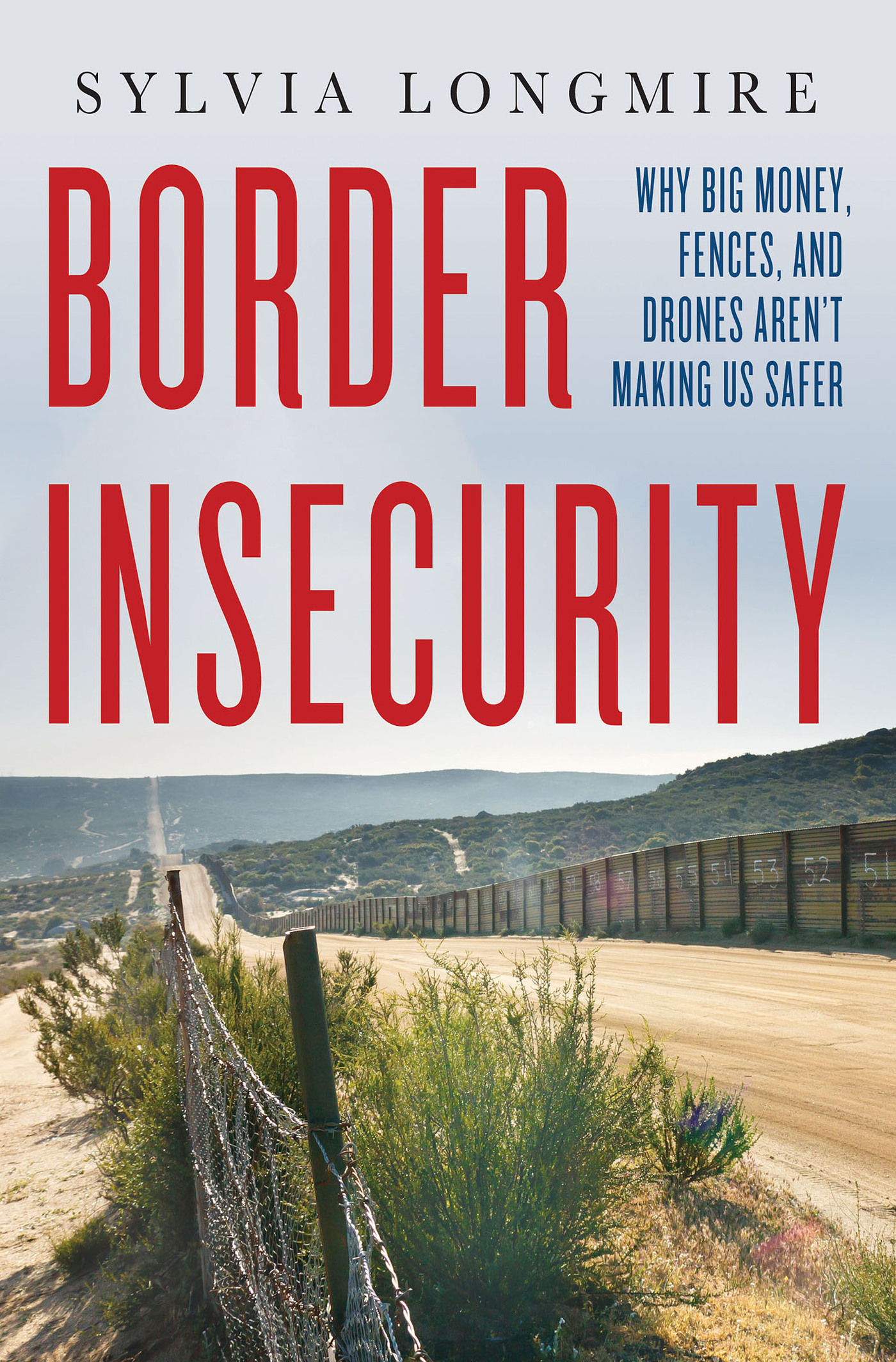
Border Insecurity When confronted with the challenges of border security and illegal immigration, government officials are fond of saying that our borders have never been as safe and secure as they are now. But ranchers in the borderlands of Arizona and Texas fear for their lands, their cattle, their homes, and sometimes their lives due to the human and drug smuggling traffic that regularly crosses their property. Who is right? What does a secure border actually look like? More importantly, is a secure border a realistic goal for the United States? Border Insecurity examines all the aspects of the challenge—and thriving industry—of trying to keep terrorists, drug smugglers, and illegal immigrants from entering the United States across our land borders. It looks at on-the-ground issues and controversies like the border fence, the usefulness of technology, shifts in the connection between illegal immigration and drug smuggling, and the potential for terrorists and drug cartels to work together. Border Insecurity also delves into how the border debate itself is part of why the government has failed to improve information sharing and why this is necessary to establish a clear and comprehensive border security strategy. POLITICAL SCIENCE,Security (National & International)

On Limited Nuclear War in the 21st Century The last two decades have seen a slow but steady increase in nuclear armed states, and in the seemingly less constrained policy goals of some of the newer "rogue" states in the international system. The authors ofOn Limited Nuclear War in the 21st Century argue that a time may come when one of these states makes the conscious decision that using a nuclear weapon against the United States, its allies, or forward deployed forces in the context of a crisis or a regional conventional conflict may be in its interests. They assert that we are unprepared for these types of limited nuclear wars and that it is urgent we rethink the theory, policy, and implementation of force related to our approaches to this type of engagement. Together they critique Cold War doctrine on limited nuclear war and consider a number of the key concepts that should govern our approach to limited nuclear conflict in the future. These include identifying the factors likely to lead to limited nuclear war, examining the geopolitics of future conflict scenarios that might lead to small-scale nuclear use, and assessing strategies for crisis management and escalation control. Finally, they consider a range of strategies and operational concepts for countering, controlling, or containing limited nuclear war. POLITICAL SCIENCE,Security (National & International)
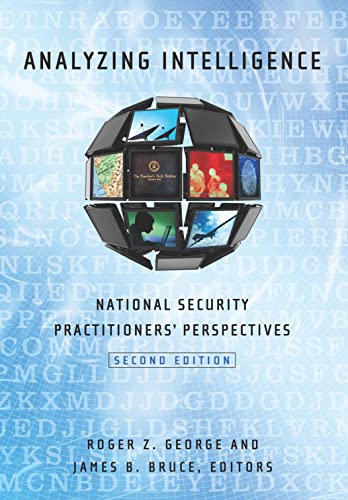
Analyzing Intelligence Analyzing Intelligence, now in a revised and extensively updated second edition, assesses the state of the profession of intelligence analysis from the practitioner's point of view. The contributors—most of whom have held senior positions in the US intelligence community—review the evolution of the field, the rise of new challenges, and how intelligence analysis is changing—and must change—to deal with 21st century national security problems. New chapters highlight advances in the intelligence community in structured analytic techniques, training, expertise-building, and professional development. Written for national security practitioners and for scholars and students studying the role of intelligence, its strengths and weaknesses, and its future directions, Analyzing Intelligence is essential reading for anyone seeking an understanding of the role and performance of analysis in US intelligence. POLITICAL SCIENCE,Security (National & International)

Busted Sanctions Powerful countries like the United States regularly employ economic sanctions as a tool for promoting their foreign policy interests. Yet this foreign policy tool has an uninspiring track record of success, with economic sanctions achieving their goals less than a third of the time they are imposed. The costs of these failed sanctions policies can be significant for the states that impose them, their targets, and the other countries they affect. Explaining economic sanctions' high failure rate therefore constitutes a vital endeavor for academics and policy-makers alike. Busted Sanctions seeks to provide this explanation, and reveals that the primary cause of this failure is third-party spoilers, or sanctions busters, who undercut sanctioning efforts by providing their targets with extensive foreign aid or sanctions-busting trade. In quantitatively and qualitatively analyzing over 60 years of U.S. economic sanctions, Bryan Early reveals that both types of third-party sanctions busters have played a major role in undermining U.S. economic sanctions. Surprisingly, his analysis also reveals that the United States' closest allies are often its sanctions' worst enemies. The book offers the first comprehensive explanation for why different types of sanctions busting occur and reveals the devastating effects it has on economic sanctions' chances of success. POLITICAL SCIENCE,Security (National & International)
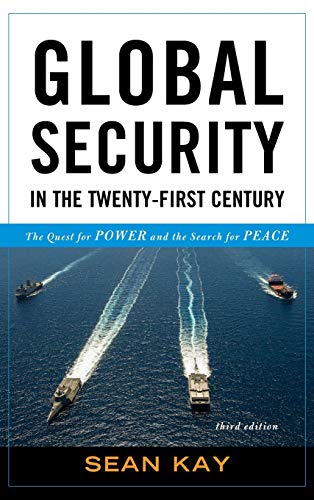
Global Security in the Twenty-First Century This thoroughly updated edition offers a balanced introduction to contemporary security dilemmas throughout the world. Writing in an engaging style, Sean Kay integrates traditional and emerging challenges in one easily accessible study that gives readers the tools they need to develop a thoughtful and nuanced understanding of global security. POLITICAL SCIENCE,Security (National & International)

The Fight The New York Times bestseller! "The Fight shines a much needed light on the troubling games DC politicians and insiders play with the American people." -Sean Hannity "The Fight is a lesson plan for fighting back against the Washington DC political machine." - Mark Levin In The Fight, Dan Bongino picks up the story where his New York Times bestselling book Life Inside the Bubble ends, tackling current political and security issues and offering new solutions. From Hillary's emails to the security failings at the White House (including the drone crash and the fence jumper); from Charlie Hebdo to Bowe Bergdahl--the author examines how our current administration has allowed our security efforts to lapse both at home and abroad. He also offers solutions to the growing terrorist threat and how we can protect American citizens while also deconstructing what's wrong with our political process and what his experience running for office has taught him. As a former member of the elite Presidential Protection Division who served three Presidents, Bongino is uniquely qualified to provide a view from behind the curtain to warn readers about the political system that is failing them, and the security future that won't protect them. The majority of Americans only come into contact with security when they fly or enter their workplace. They are rarely able to become acquainted with the politicians they know from robo-calls and TV ads. Bongino has experienced the inner-workings of the national security apparatus and the failed political theater that we all feel but rarely understand. Using a mix of current events, an insider's analysis, and tales from his time protecting the president, he shows where clear and foreseeable leadership failures from our current administration led to grave consequences. From a broken political process to a president who consistently misreads the American people, he shows us where America has gone wrong and how we can fight back. POLITICAL SCIENCE,Security (National & International)

The Use of Force This book brings together enduring, influential works on the role of military power in foreign policy and international politics. Now in its eighth edition, this fully updated reader has been significantly revised with twenty innovative and up-to-date selections meticulously chosen and edited by leading scholars Robert Art and Kelly Greenhill. POLITICAL SCIENCE,Security (National & International)

Introduction to Homeland Security Introduction to Homeland Security: Principles of All-Hazards Risk Management, Fifth Edition, provides users with a substantially updated version of previous versions, clearly delineating the bedrock principles of preparing for, mitigating, managing, and recovering from emergencies and disasters, while also offering a balanced account of all aspects of homeland security. This new edition features coverage of the Boston Marathon bombing, analysis of the NIST Cybersecurity Framework for critical infrastructure protection, and examines the DHS “Blue Campaign to stop human trafficking. To provide added perspective, this edition features additional “another voice sections and examines the emergence of social media as a tool for reporting on homeland security issues. Provides users with a comprehensive understanding of the bedrock principles of preparing for, mitigating, managing, and recovering from emergencies and disasters Features coverage of the Boston Marathon bombing and analysis of the NIST Cybersecurity Framework for critical infrastructure protection Examines the emergence of social media as a tool for reporting on homeland security issues POLITICAL SCIENCE,Security (National & International)
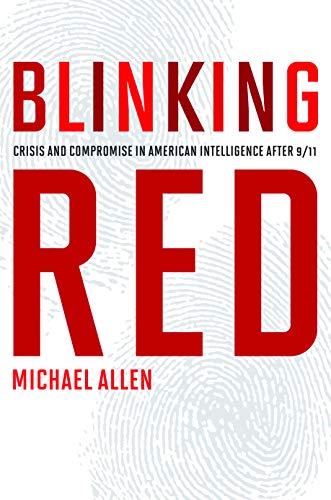
Blinking Red After the September 11 attacks, the 9/11 Commission argued that the United States needed a powerful leader, a spymaster, to forge the scattered intelligence bureaucracies into a singular enterprise to vanquish America’s new enemies—stateless international terrorists. In the midst of the 2004 presidential election, Congress and the president remade the post–World War II national security infrastructure in less than five months, creating the Office of the Director of National Intelligence (DNI) and a National Counterterrorism Center (NCTC). Blinking Red illuminates the complicated history of the bureaucratic efforts to reform America’s national security after the intelligence failures of 9/11 and Iraq’s missing weapons of mass destruction, explaining how the NSC and Congress shaped the U.S. response to the 9/11 attacks. Michael Allen asserts that the process of creating the DNI position and the NCTC is a case study in power politics and institutional reform. By bringing to light the legislative transactions and political wrangling during the reform of the intelligence community, Allen helps us understand why the effectiveness of these institutional changes is still in question. POLITICAL SCIENCE,Security (National & International)

An Introduction to Non-Traditional Security Studies Providing students with a complete introduction to the area, with thoroughly-developed pedagogy to both guide those new to the topic and challenge those who are already engaged, this new textbook brings together leaders in the field to cover all key contemporary issues in depth. POLITICAL SCIENCE,Security (National & International)
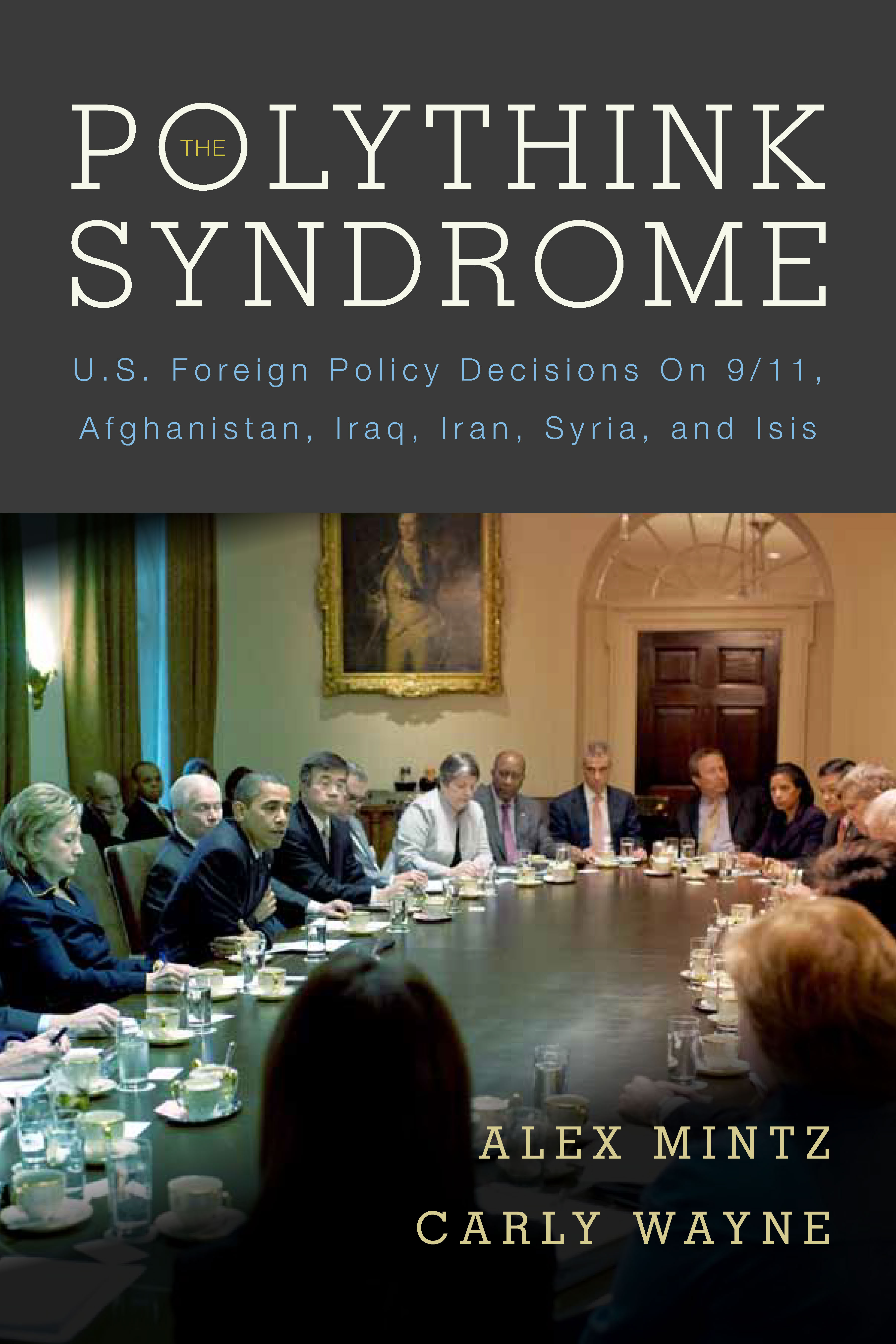
The Polythink Syndrome Why do presidents and their advisors often make sub-optimal decisions on military intervention, escalation, de-escalation, and termination of conflicts? The leading concept of group dynamics, groupthink, offers one explanation: policy-making groups make sub-optimal decisions due to their desire for conformity and uniformity over dissent, leading to a failure to consider other relevant possibilities. But presidential advisory groups are often fragmented and divisive. This book therefore scrutinizes polythink, a group decision-making dynamic whereby different members in a decision-making unit espouse a plurality of opinions and divergent policy prescriptions, resulting in a disjointed decision-making process or even decision paralysis. The book analyzes eleven national security decisions, including the national security policy designed prior to the terrorist attacks of 9/11, the decisions to enter into and withdraw from Afghanistan and Iraq, the 2007 "surge" decision, the crisis over the Iranian nuclear program, the UN Security Council decision on the Syrian Civil War, the faltering Kerry Peace Process in the Middle East, and the U.S. decision on military operations against ISIS. Based on the analysis of these case studies, the authors address implications of the polythink phenomenon, including prescriptions for avoiding and/or overcoming it, and develop strategies and tools for what they call Productive Polythink. The authors also show the applicability of polythink to business, industry, and everyday decisions. POLITICAL SCIENCE,Security (National & International)

New Tools for Collaboration This report identifies lessons learned from looking at the use of internal collaborative tools across the Intelligence Community, especially across the four biggest agencies: Central Intelligence Agency, Defense Intelligence Agency, National Security Agency, and National Geospatial Intelligence Agency. POLITICAL SCIENCE,Security (National & International)
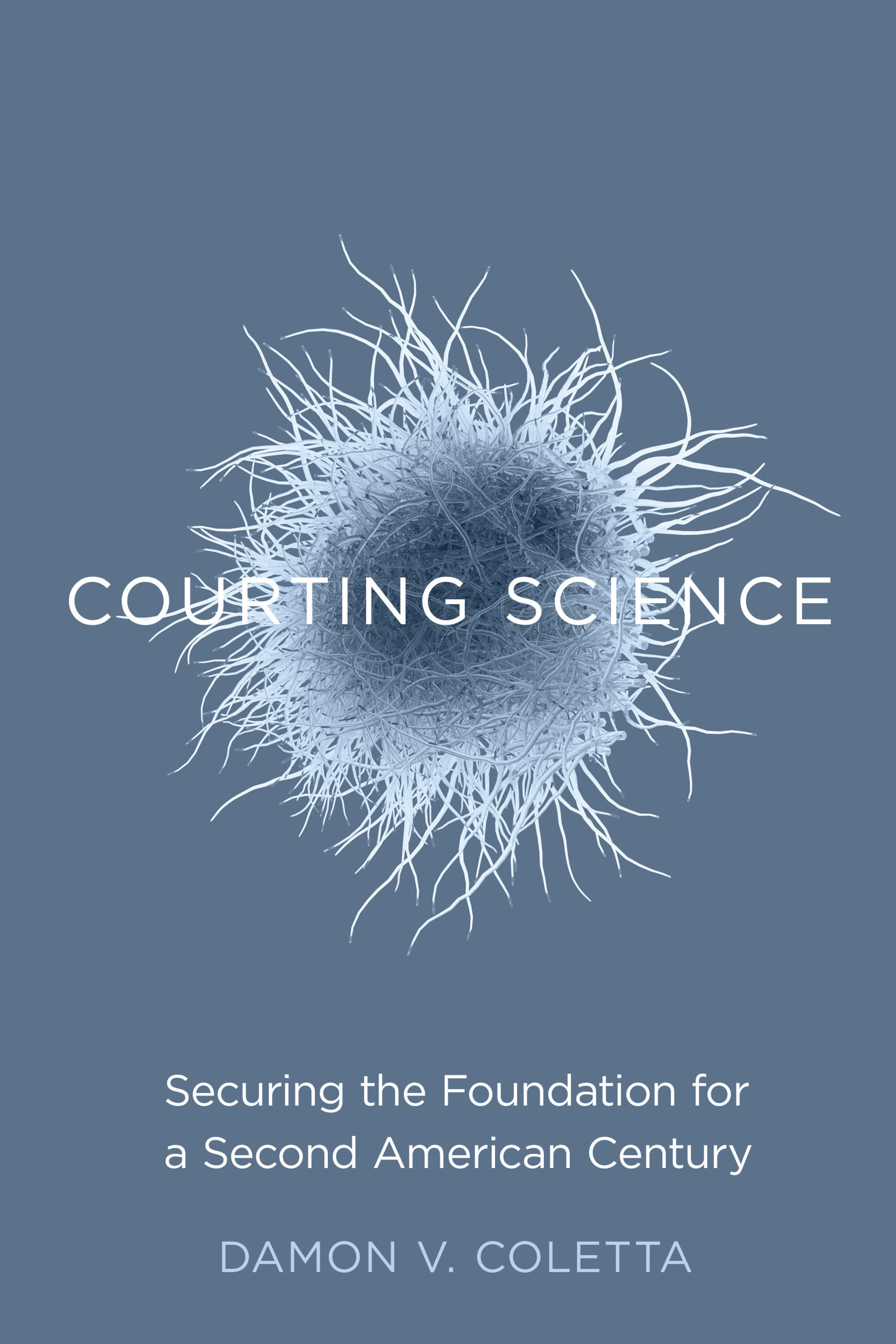
Courting Science In Courting Science, Damon Coletta offers a novel explanation for the decline of American leadership in world affairs. Whether the American Century ends sooner rather than later may depend on America's capacity for self-reflection and, ultimately, self-restraint when it comes to science, technology, and engineering. Democracy's affinity for advanced technology has to be balanced against scientific research and progress as a global enterprise. In an era of rising challengers to America's lead in the international order and an increasingly globalized civil society, a "Scientific State" has a better chance of extending its dominance. In order to draw closer to this ideal, though, the United States will have to reconsider its grand strategy. It must have a strategy that scrutinizes how tightly it constrains, how narrowly it directs, and how far it trusts American scientists. If given the opportunity, scientists have the potential to lead a second American Century through domestic science and technology policy, international diplomacy, and transnational networks for global governance. POLITICAL SCIENCE,Security (National & International)

What Do We Know about Civil Wars? In this timely book, leading scholars guide us through what the latest research tells us about the onset, duration, outcomes, and recurrence of civil wars, as well as the ongoing consequences of conflicts in war-torn countries such as Syria, Sudan, and Rwanda. POLITICAL SCIENCE,Security (National & International)

Practical Aviation Security Practical Aviation Security: Predicting and Preventing Future Threats, Third Edition is a complete guide to the aviation security system, from crucial historical events to the policies, policymakers, and major terrorist and criminal acts that have shaped the procedures in use today, as well as the cutting edge technologies that are shaping the future. This text equips readers working in airport security or other aviation management roles with the knowledge to implement effective security programs, meet international guidelines, and responsibly protect facilities or organizations of any size. Using case studies and practical security measures now in use at airports worldwide, readers learn the effective methods and the fundamental principles involved in designing and implementing a security system. The aviation security system is comprehensive and requires continual focus and attention to stay a step ahead of the next attack. Practical Aviation Security, Third Edition, helps prepare practitioners to enter the industry and helps seasoned professionals prepare for new threats and prevent new tragedies. Covers commercial airport security, general aviation and cargo operations, threats, threat detection and response systems, as well as international security issues Lays out the security fundamentals that can ensure the future of global travel and commerce Applies real-world aviation experience to the task of anticipating and deflecting threats Includes updated coverage of security related to spaceport and unmanned aerial systems, focusing on IACO (International Civil Aviation Organization) security regulations and guidance Features additional and updated case studies and much more POLITICAL SCIENCE,Security (National & International)

Post-War Statebuilding and Constitutional Reform Sebastián explores the experience of statebuilding and constitution making after violent conflict, using the failed reform of Dayton in Bosnia and Herzegovina as a case study to reflect upon the fundamental questions of post-war statebuilding, reform and the role of local and external actors. POLITICAL SCIENCE,Security (National & International)

Spy Sites of Washington, DC This one-of-a-kind guidebook lifts the cloak on over two centuries of espionage in the Washington region. Robert Wallace and H. Keith Melton tell the stories and give coordinates for the headline-making cases and long-forgotten spy games that have changed the course of world affairs. With 220 main entries as well as listings for dozens more spy sites, maps and more than 300 photos this guide makes it easy for anyone to follow in the elusive footsteps of the moles, traitors, sleuths, and spies who lived the shadow history of our nation's capital. POLITICAL SCIENCE,Security (National & International)
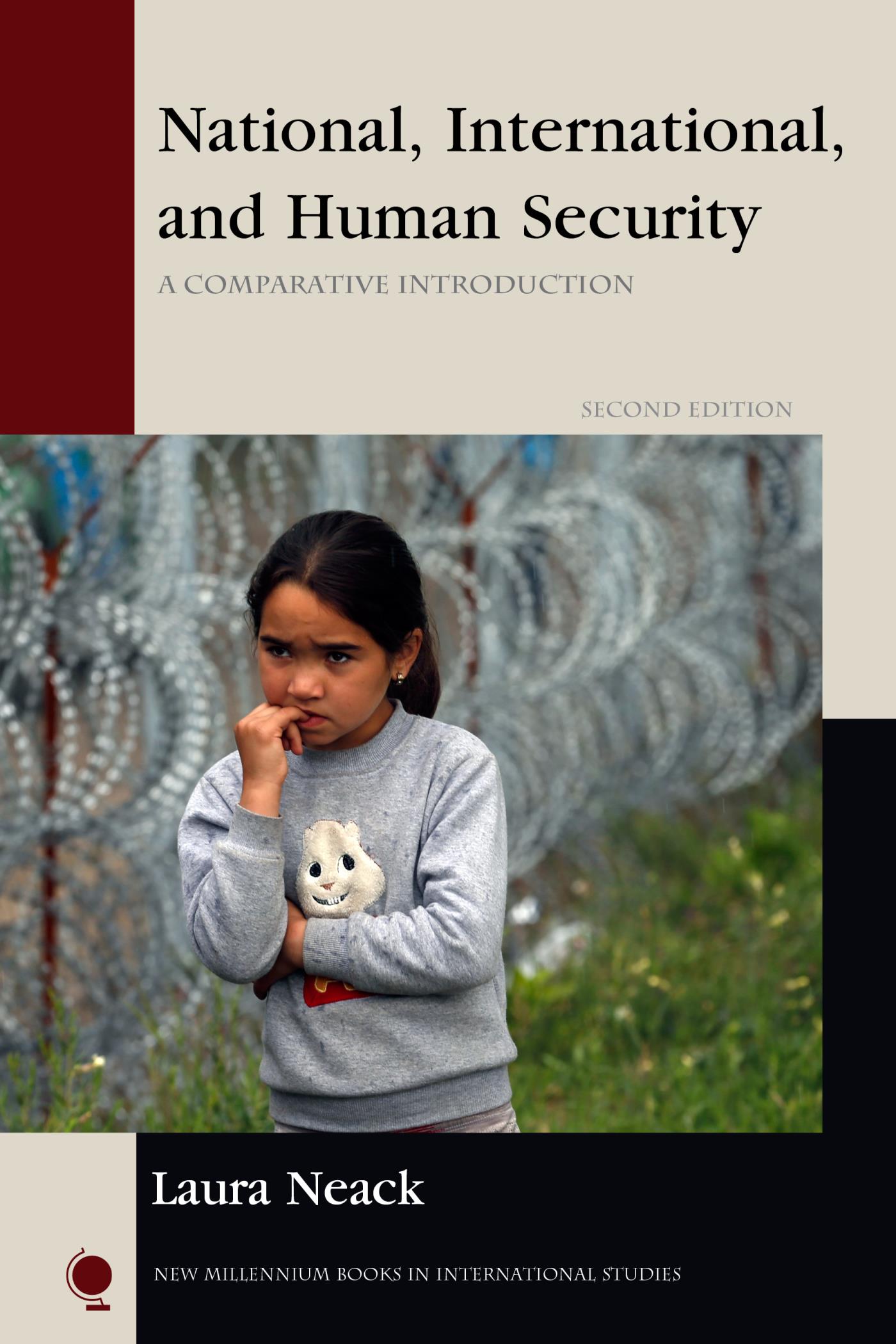
National, International, and Human Security This concise updated edition offers a clear and comprehensive comparison of national, international, and human security. Laura Neack frames key concepts and policies, paired with timely new case studies, arguing that security remains elusive due to a centuries-old ethic insisting that states are the only viable international actors. POLITICAL SCIENCE,Security (National & International)

The Securitisation of Migration in the EU Since 9/11 Western states have sought to integrate 'securitisation' measures within migration regimes as asylum seekers and other migrant categories come to be seen as agents of social instability or as potential terrorists. Treating migration as a security threat has therefore increased insecurity amongst migrant and ethnic minority populations. POLITICAL SCIENCE,Security (National & International)
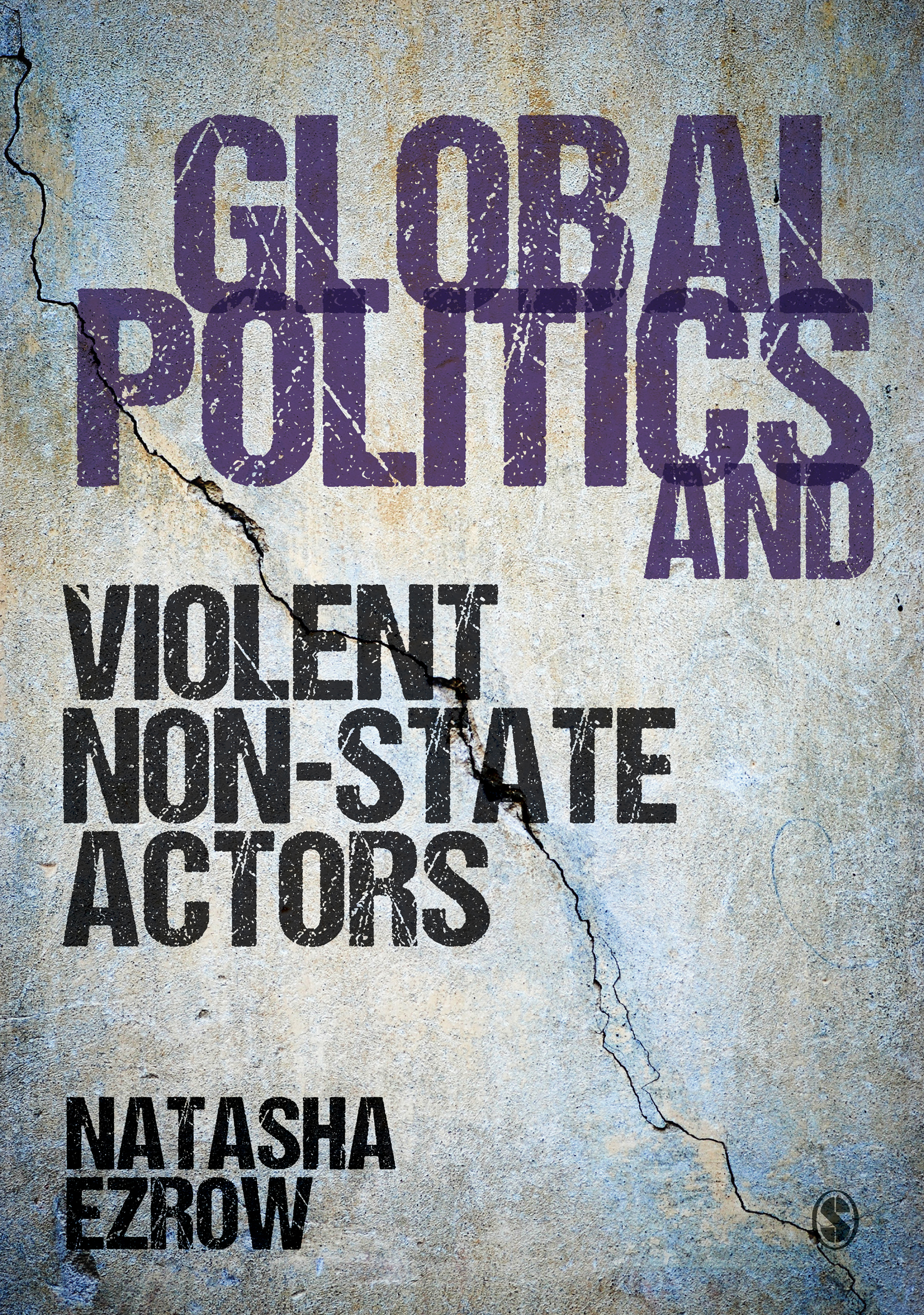
Global Politics and Violent Non-state Actors With inclusion of theories and causal factors for context, plenty of case studies for real-world application, and pedagogical features to encourage engagement, this book’s coverage also goes far beyond the traditional focus on terrorist groups to provide readers with a stimulating and wide-ranging introduction to the subject POLITICAL SCIENCE,Security (National & International)

Hard Target Because authoritarian regimes like North Korea can impose the costs of sanctions on their citizens, these regimes constitute "hard targets." Yet authoritarian regimes may also be immune—and even hostile—to economic inducements if such inducements imply reform and opening. This book captures the effects of sanctions and inducements on North Korea and provides a detailed reconstruction of the role of economic incentives in the bargaining around the country's nuclear program. Stephan Haggard and Marcus Noland draw on an array of evidence to show the reluctance of the North Korean leadership to weaken its grip on foreign economic activity. They argue that inducements have limited effect on the regime, and instead urge policymakers to think in terms of gradual strategies. Hard Target connects economic statecraft to the marketization process to understand North Korea and addresses a larger debate over the merits and demerits of "engagement" with adversaries. POLITICAL SCIENCE,Security (National & International)

The National Security Enterprise This second edition of The National Security Enterprise provides practitioners’ insights into the operation, missions, and organizational cultures of the principal national security agencies and other institutions that shape the US national security decision-making process. Unlike some textbooks on American foreign policy, it offers analysis from insiders who have worked at the National Security Council, the State and Defense Departments, the intelligence community, and the other critical government entities. POLITICAL SCIENCE,Security (National & International)
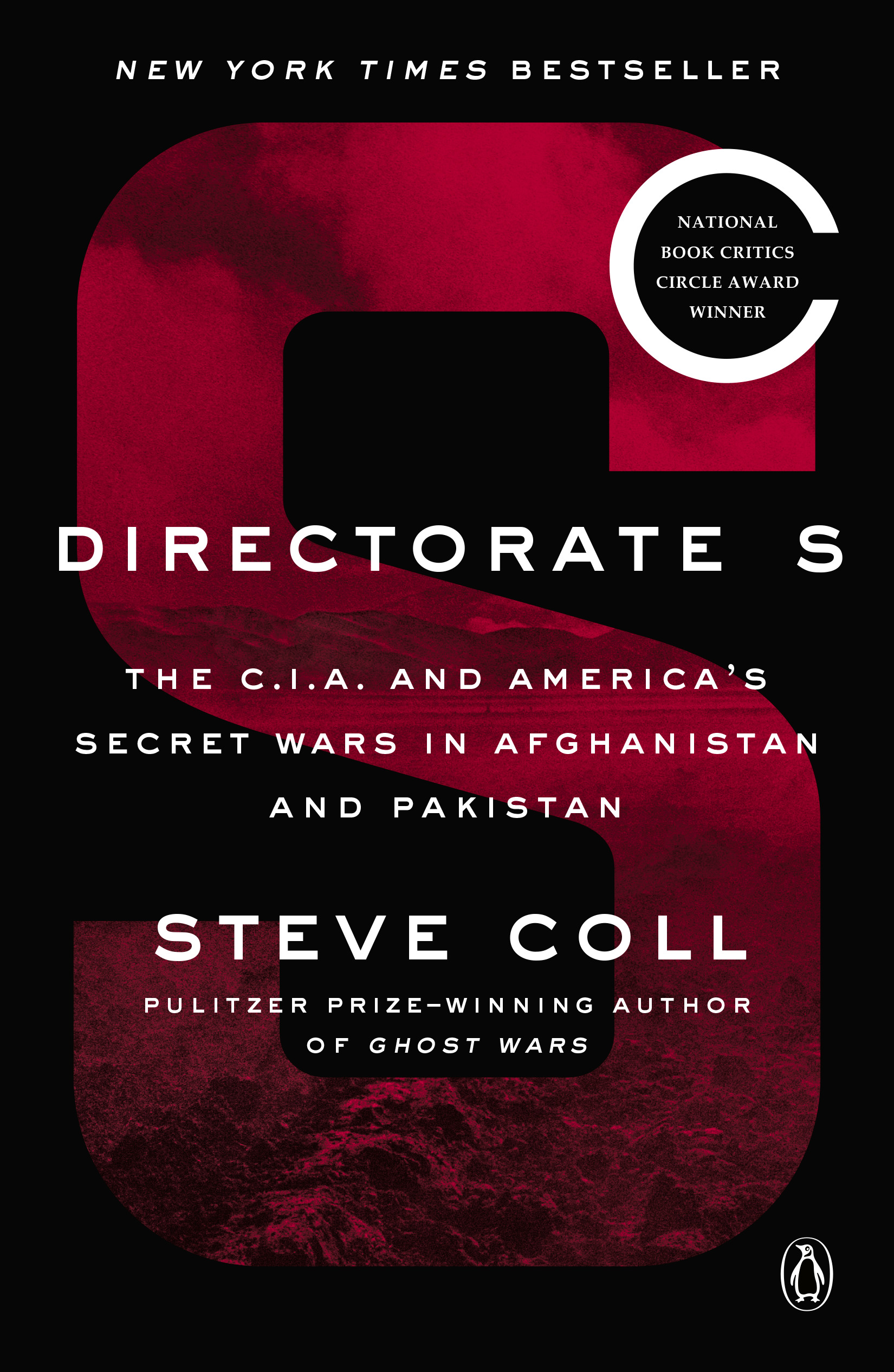
Directorate S Winner of the 2018 National Book Critics Circle Award for Nonfiction Longlisted for the 2018 National Book Award for Nonfiction From the Pulitzer Prize-winning author of Ghost Wars, the epic and enthralling story of America's intelligence, military, and diplomatic efforts to defeat Al Qaeda and the Taliban in Afghanistan and Pakistan since 9/11 Prior to 9/11, the United States had been carrying out small-scale covert operations in Afghanistan, ostensibly in cooperation, although often in direct opposition, with I.S.I., the Pakistani intelligence agency. While the US was trying to quell extremists, a highly secretive and compartmentalized wing of I.S.I., known as "Directorate S," was covertly training, arming, and seeking to legitimize the Taliban, in order to enlarge Pakistan's sphere of influence. After 9/11, when fifty-nine countries, led by the U. S., deployed troops or provided aid to Afghanistan in an effort to flush out the Taliban and Al Qaeda, the U.S. was set on an invisible slow-motion collision course with Pakistan. Today we know that the war in Afghanistan would falter badly because of military hubris at the highest levels of the Pentagon, the drain on resources and provocation in the Muslim world caused by the U.S.-led invasion of Iraq, and corruption. But more than anything, as Coll makes painfully clear, the war in Afghanistan was doomed because of the failure of the United States to apprehend the motivations and intentions of I.S.I.'s "Directorate S". This was a swirling and shadowy struggle of historic proportions, which endured over a decade and across both the Bush and Obama administrations, involving multiple secret intelligence agencies, a litany of incongruous strategies and tactics, and dozens of players, including some of the most prominent military and political figures. A sprawling American tragedy, the war was an open clash of arms but also a covert melee of ideas, secrets, and subterranean violence. Coll excavates this grand battle, which took place away from the gaze of the American public. With unsurpassed expertise, original research, and attention to detail, he brings to life a narrative at once vast and intricate, local and global, propulsive and painstaking. This is the definitive explanation of how America came to be so badly ensnared in an elaborate, factional, and seemingly interminable conflict in South Asia. Nothing less than a forensic examination of the personal and political forces that shape world history, Directorate S is a complete masterpiece of both investigative and narrative journalism. POLITICAL SCIENCE,Security (National & International)
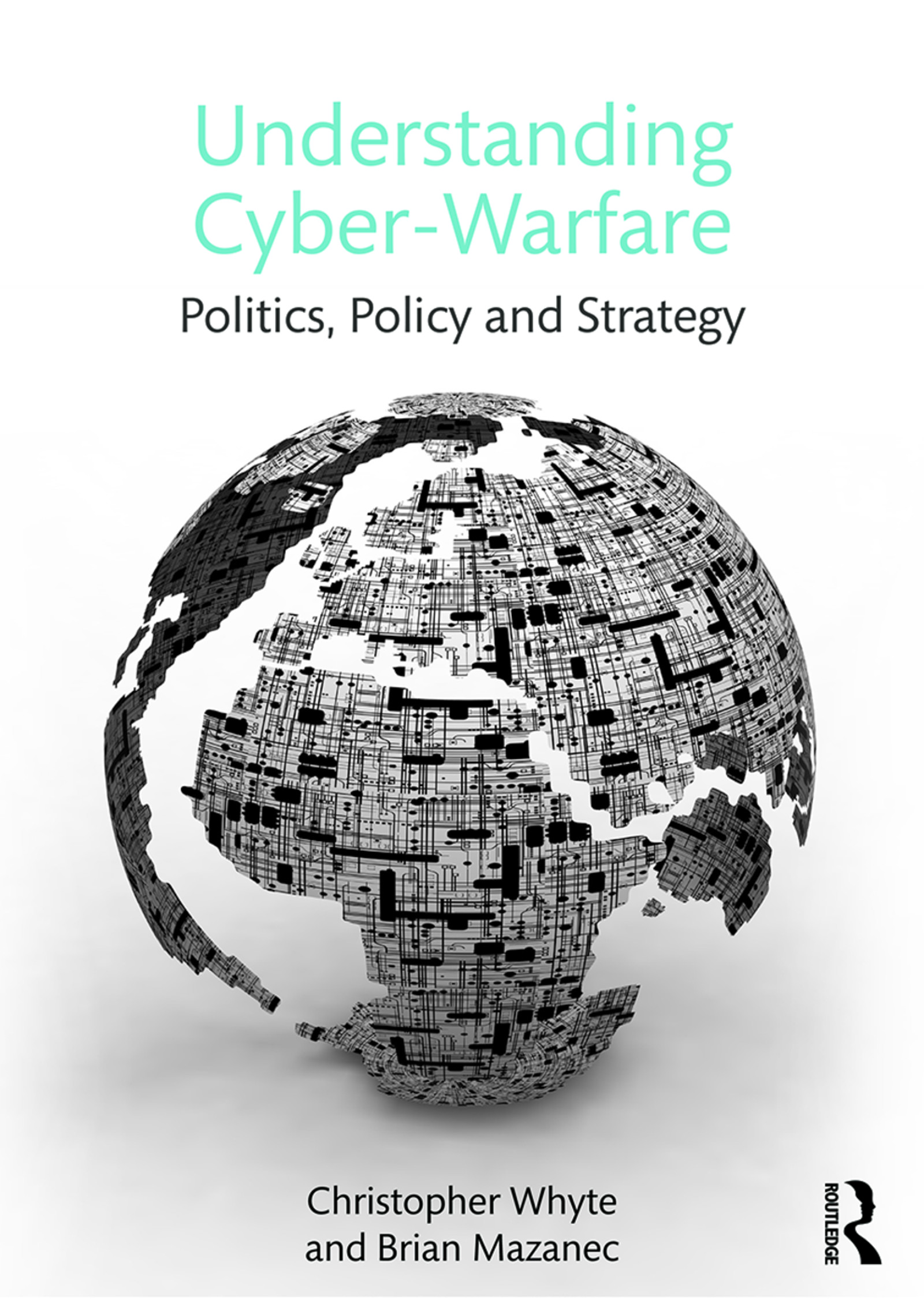
Understanding Cyber Warfare This textbook offers an accessible introduction to the historical, technical, and strategic context of cyber conflict. The international relations, policy, doctrine, strategy, and operational issues associated with computer network attack, computer network exploitation, and computer network defense are collectively referred to as cyber warfare. This new textbook provides students with a comprehensive perspective on the technical, strategic, and policy issues associated with cyber conflict as well as an introduction to key state and non-state actors. Specifically, the book provides a comprehensive overview of these key issue areas: the historical emergence and evolution of cyber warfare, including the basic characteristics and methods of computer network attack, exploitation, and defense; a theoretical set of perspectives on conflict in the digital age from the point of view of international relations (IR) and the security studies field; the current national perspectives, policies, doctrines, and strategies relevant to cyber warfare; and an examination of key challenges in international law, norm development, and the potential impact of cyber warfare on future international conflicts. This book will be of much interest to students of cyber conflict and other forms of digital warfare, security studies, strategic studies, defense policy, and, most broadly, international relations. POLITICAL SCIENCE,Security (National & International)

The European Union as an Actor in Security Sector Reform This book critically analyzes the European Union’s role in Security Sector Reform (SSR), a topical issue with regards to European security. While the literature on SSR has increased significantly in the past decade, too little remain in the way of comparative analyses of SSR case studies that are geared toward theory development. This collection strives to push the SSR literature in that direction. One key question it focuses on is whether the EU pursues a holistic approach vis-à -vis SSR. Another question the book addresses is why and how the EU activities towards SSR in conflict management, peacebuilding and statebuilding have produced a wide variety of outcomes that range from the failure to reform any or all of the sub-set of security sectors (police, justice, military, etc.) to complete and integrated reform. The volume encompasses all relevant cases of SSR in terms of the financial, human, and political resources involved at the EU level. Cases are drawn from the Balkans (Kosovo; Bosnia-Herzegovina), Africa (Democratic Republic of Congo), the Middle East (Palestinian Territories), Post-Soviet Space (Georgia), and Asia (Aceh, Indonesia). The end product is a welcome contribution to the literature, providing both an empirically and theoretically grounded approach to the study of SSR. This book was originally published as a special issue of European Security. POLITICAL SCIENCE,Security (National & International)
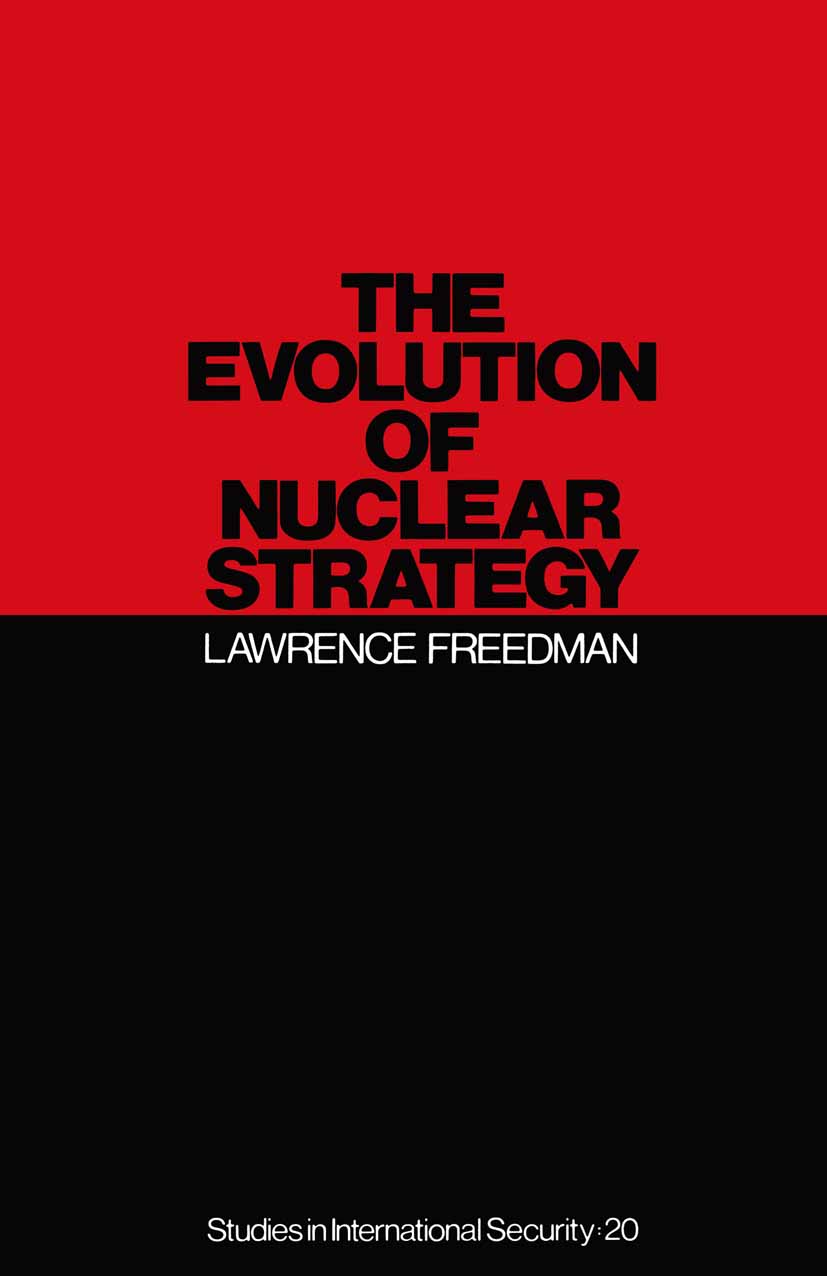
Evolution of Nuclear Strategy POLITICAL SCIENCE,Security (National & International)

Small Wars, Big Data How a new understanding of warfare can help the military fight today’s conflicts more effectively The way wars are fought has changed starkly over the past sixty years. International military campaigns used to play out between large armies at central fronts. Today's conflicts find major powers facing rebel insurgencies that deploy elusive methods, from improvised explosives to terrorist attacks. Small Wars, Big Data presents a transformative understanding of these contemporary confrontations and how they should be fought. The authors show that a revolution in the study of conflict--enabled by vast data, rich qualitative evidence, and modern methods—yields new insights into terrorism, civil wars, and foreign interventions. Modern warfare is not about struggles over territory but over people; civilians—and the information they might choose to provide—can turn the tide at critical junctures. The authors draw practical lessons from the past two decades of conflict in locations ranging from Latin America and the Middle East to Central and Southeast Asia. Building an information-centric understanding of insurgencies, the authors examine the relationships between rebels, the government, and civilians. This approach serves as a springboard for exploring other aspects of modern conflict, including the suppression of rebel activity, the role of mobile communications networks, the links between aid and violence, and why conventional military methods might provide short-term success but undermine lasting peace. Ultimately the authors show how the stronger side can almost always win the villages, but why that does not guarantee winning the war. Small Wars, Big Data provides groundbreaking perspectives for how small wars can be better strategized and favorably won to the benefit of the local population. POLITICAL SCIENCE,Security (National & International)

Human Security This book examines the roots of human security, connecting its origins to its applications and challenges in war and peacetime. POLITICAL SCIENCE,Security (National & International)
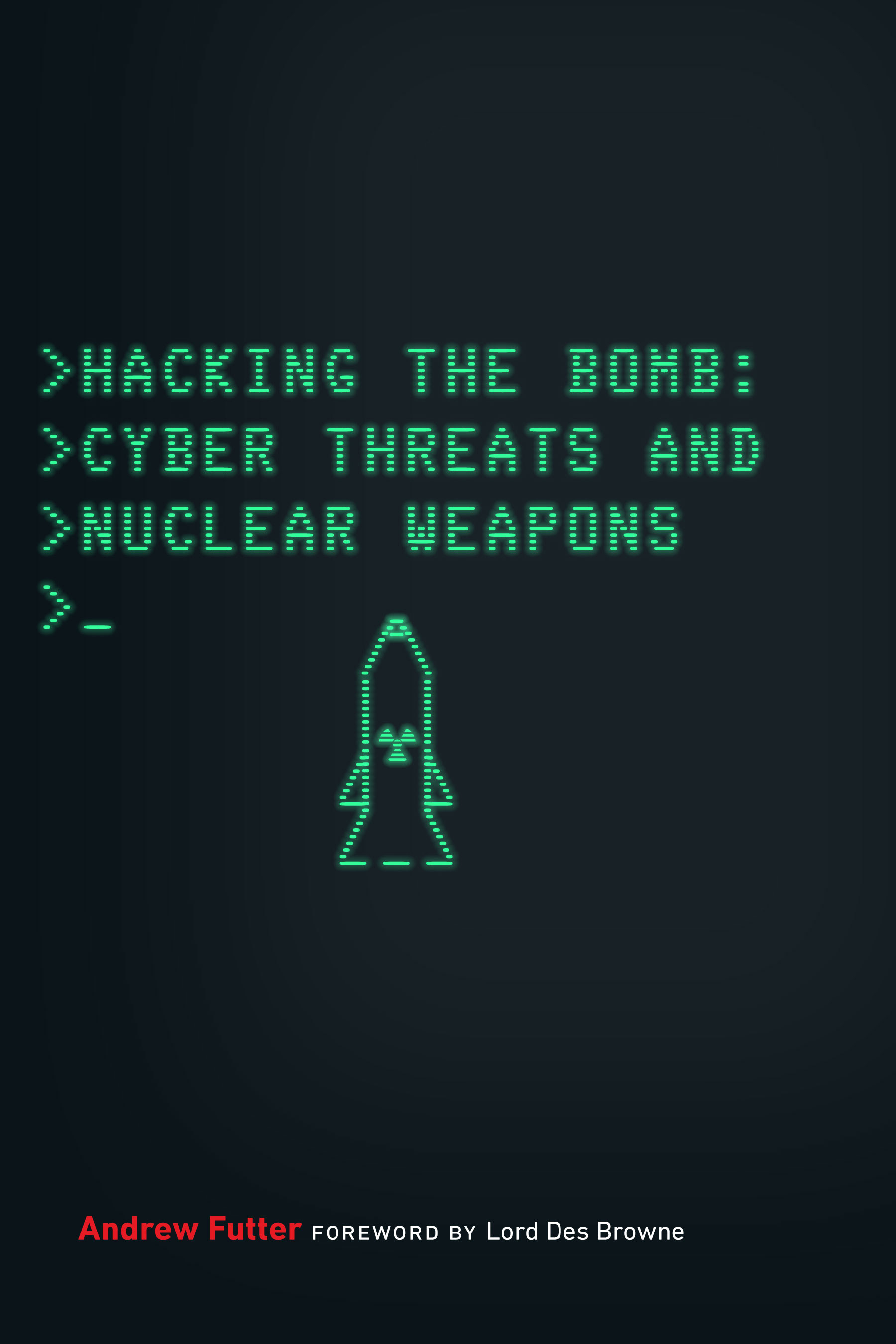
Hacking the Bomb Are nuclear arsenals safe from cyber-attack? Could terrorists launch a nuclear weapon through hacking? Are we standing at the edge of a major technological challenge to global nuclear order? These are among the many pressing security questions addressed in Andrew Futter’s ground-breaking study of the cyber threat to nuclear weapons. Hacking the Bomb provides the first ever comprehensive assessment of this worrying and little-understood strategic development, and it explains how myriad new cyber challenges will impact the way that the world thinks about and manages the ultimate weapon. The book cuts through the hype surrounding the cyber phenomenon and provides a framework through which to understand and proactively address the implications of the emerging cyber-nuclear nexus. It does this by tracing the cyber challenge right across the nuclear weapons enterprise, explains the important differences between types of cyber threats, and unpacks how cyber capabilities will impact strategic thinking, nuclear balances, deterrence thinking, and crisis management. The book makes the case for restraint in the cyber realm when it comes to nuclear weapons given the considerable risks of commingling weapons of mass disruption with weapons of mass destruction, and argues against establishing a dangerous norm of “hacking the bomb.†This timely book provides a starting point for an essential discussion about the challenges associated with the cyber-nuclear nexus, and will be of great interest to scholars and students of security studies as well as defense practitioners and policy makers. POLITICAL SCIENCE,Security (National & International)
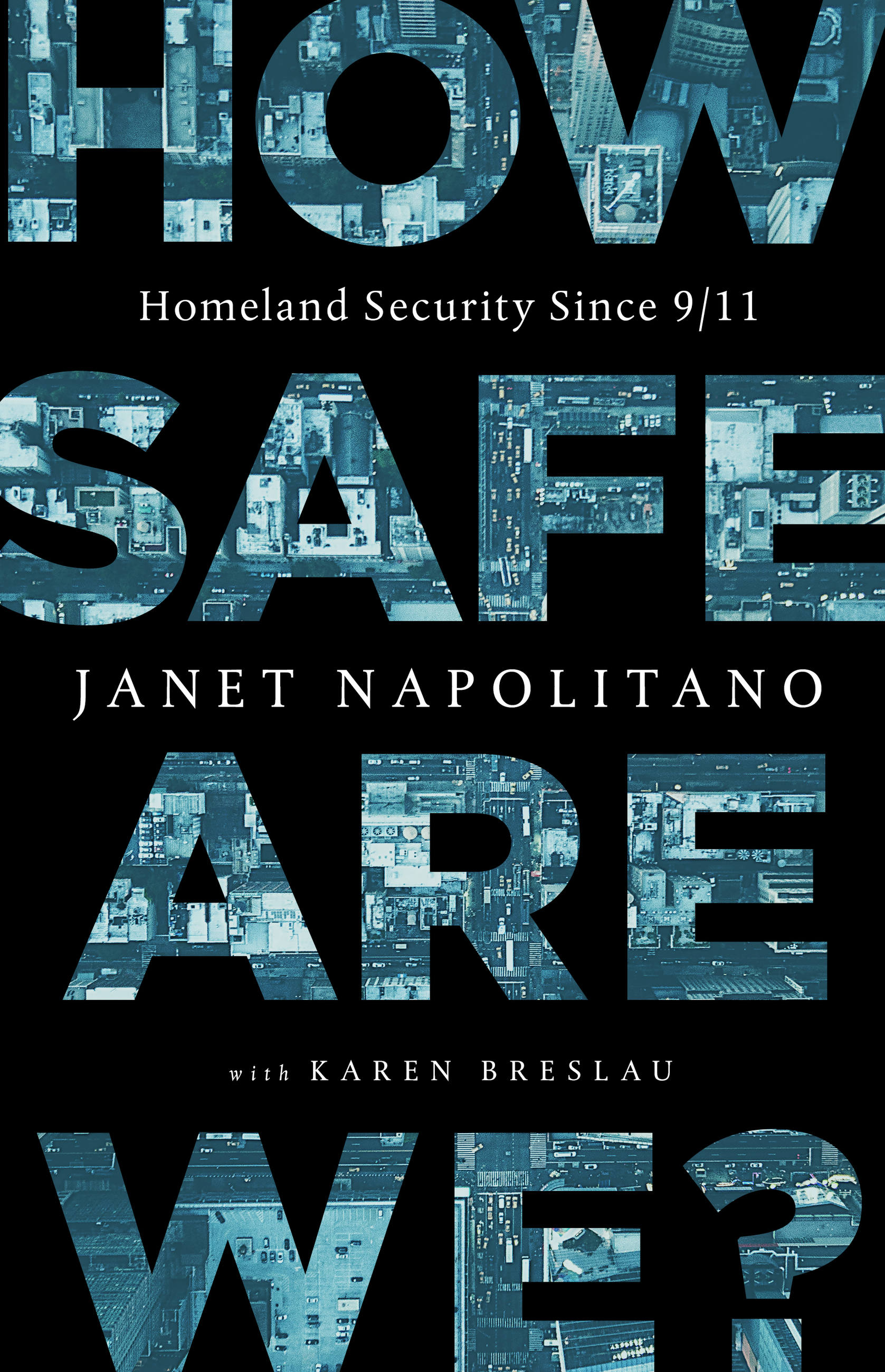
How Safe Are We? Former Secretary of the Department of Homeland Security Janet Napolitano offers an insightful analysis of American security at home and a prescription for the future. Created in the wake of the greatest tragedy to occur on U.S. soil, the Department of Homeland Security was handed a sweeping mandate: make America safer. It would encompass intelligence and law enforcement agencies, oversee natural disasters, commercial aviation, border security and ICE, cybersecurity, and terrorism, among others. From 2009-2013, Janet Napolitano ran DHS and oversaw 22 federal agencies with 230,000 employees. In How Safe Are We?, Napolitano pulls no punches, reckoning with the critics who call it Frankenstein's Monster of government run amok, and taking a hard look at the challenges we'll be facing in the future. But ultimately, she argues that the huge, multifaceted department is vital to our nation's security. An agency that's part terrorism prevention, part intelligence agency, part law enforcement, public safety, disaster recovery make for an odd combination the protocol-driven, tradition-bound Washington D.C. culture. But, she says, it has made us more safe, secure, and resilient. Napolitano not only answers the titular question, but grapples with how these security efforts have changed our country and society. Where are the failures that leave us vulnerable and what has our 1 trillion dollar investment yielded over the last 15 years? And why haven't we had another massive terrorist attack in the U.S. since September 11th, 2001? In our current political climate, where Donald Trump has politicized nearly every aspect of the department, Napolitano's clarifying, bold vision is needed now more than ever. POLITICAL SCIENCE,Security (National & International)
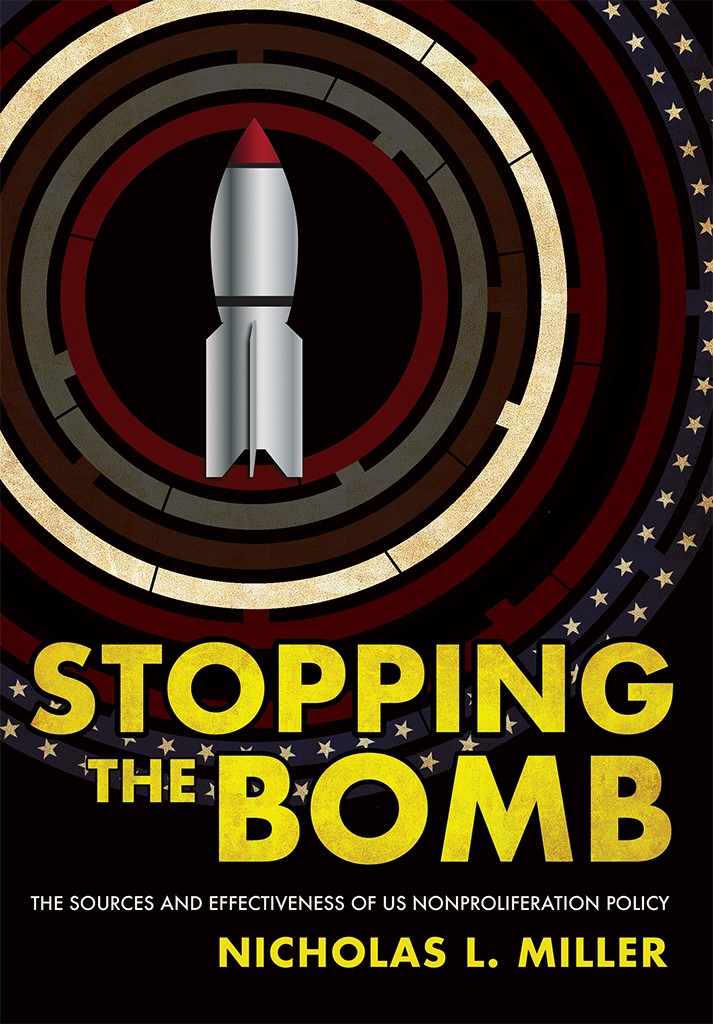
Stopping the Bomb Stopping the Bomb examines the historical development and effectiveness of American efforts to prevent the spread of nuclear weapons. Nicholas L. Miller offers here a novel theory that argues changes in American nonproliferation policy are the keys to understanding the nuclear landscape from the 1960s onward. The Chinese and Indian nuclear tests in the 1960s and 1970s forced the US government, Miller contends, to pay new and considerable attention to the idea of nonproliferation and to reexamine its foreign policies. Stopping the Bomb explores the role of the United States in combating the spread of nuclear weapons, an area often ignored to date. He explains why these changes occurred and how effective US policies have been in preventing countries from seeking and acquiring nuclear weapons. Miller's findings highlight the relatively rapid move from a permissive approach toward allies acquiring nuclear weapons to a more universal nonproliferation policy no matter whether friend or foe. Four in-depth case studies of US nonproliferation policy—toward Taiwan, Pakistan, Iran, and France—elucidate how the United States can compel countries to reverse ongoing nuclear weapons programs. Miller's findings in Stopping the Bomb have important implications for the continued study of nuclear proliferation, US nonproliferation policy, and beyond. POLITICAL SCIENCE,Security (National & International)

Energy Security Energy security has become a top priority issue for the United States and countries around the globe, but what does the term "energy security" really mean? For many it is assuring the safe supply and transport of energy as a matter of national security. For others it is developing and moving toward sustainable and low-carbon energy sources to avoid environmental catastrophe, while still others prioritize affordability and abundance of supply. The demand for energy has ramifications in every part of the globefrom growing demand in Asia, to the pursuit of reserves in Latin America and Africa, to the increased clout of energy-producing states such as Russia and Iran. Yet the fact remains that the vast majority of global energy production still comes from fossil fuels, and it will take a thorough understanding of the interrelationships of complex challengesfinite supply, environmental concerns, political and religious conflict, and economic volatilityto develop policies that will lead to true energy security. In E nergy Security, Brookings scholars present a realistic, cross-disciplinary look at the American and global quests for energy security within the context of these geopolitical, economic, and environmental challenges. For example, political analysts Pietro Nivola and Erin Carter wrap their arms around just what is means to be "energy independent" and whether that is an advisable or even feasible goal. Suzanne Maloney addresses "Energy Security in the Persian Gulf: Opportunities and Challenges," while economist Jason Bordoff and energy analyst Bryan Mignone trace the links between climate policies and energy-access policies. Carlos Pascual and his colleagues examine delicate geopolitical issues. Assuring long-term energy security remains one of the industrialized world's most pressing priorities, but steps in that direction have been controversial and often dangerous, and results thus far have been tenuous. In this insightful volume, Brookings POLITICAL SCIENCE,Security (National & International)
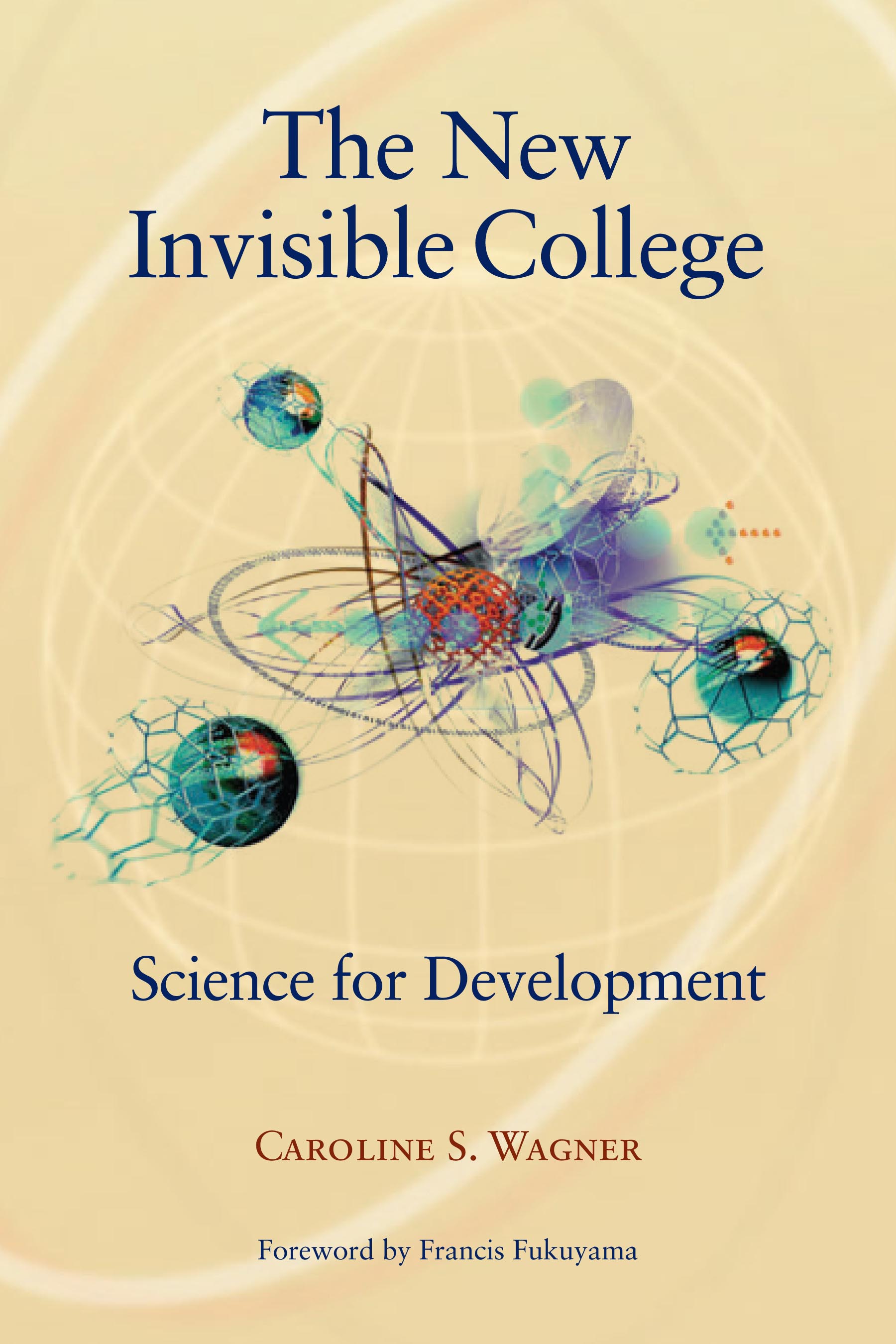
The New Invisible College The twentieth century was the era of "big science." Driven by strategic rivalries and fierce economic competition, wealthy governments invested heavily in national science establishments. Direct funding for institutions like the National Science Foundation and high-visibility projects, such as the race to the moon, fueled innovation, growth, and national prestige. But the big science model left poorer countries out in the cold. Today the organization of science is undergoing a fundamental transformation. In T he New Invisible College, Caroline Wagner combines quantitative data and extensive interviews to map the emergence of global science networks and trace the dynamics driving their growth. She argues that the shift from big science to global networks creates unprecedented opportunities for developing countries to tap science's potential. Rather than squander resources in vain efforts to mimic the scientific establishments of the twentieth century, developing country governments can leverage networks by creating incentives for top-notch scientists to focus on research that addresses their concerns and by finding ways to tie knowledge to local problem solving. T he New Invisible College offers both a guidebook and a playbook for policymakers confronting these tasks. POLITICAL SCIENCE,Security (National & International)

Securing Japan The definitive assessment of Japanese security policy and its implications for the future of East Asia. POLITICAL SCIENCE,Security (National & International)

The End of Grand Strategy In The End of Grand Strategy, Simon Reich and Peter Dombrowski challenge the common view of grand strategy as unitary. They eschew prescription of any one specific approach, chosen from a spectrum that stretches from global primacy to restraint and isolationism, in favor of describing what America’s military actually does, day to day. They argue that a series of fundamental recent changes in the global system, the inevitable jostling of bureaucratic politics, and the practical limitations of field operations combine to ensure that each presidential administration inevitably resorts to a variety of strategies. Proponents of different American grand strategies have historically focused on the pivotal role of the Navy. In response, Reich and Dombrowski examine six major maritime operations, each of which reflects one major strategy. One size does not fit all, say the authors—the attempt to impose a single overarching blueprint is no longer feasible. Reich and Dombrowski declare that grand strategy, as we know it, is dead. The End of Grand Strategy is essential reading for policymakers, military strategists, and analysts and critics at advocacy groups and think tanks. POLITICAL SCIENCE,Security (National & International)

Bombing to Win In this now-classic work of the theory and practice of airpower and its political effects, Robert A. Pape helps military strategists and policy makers judge the purpose of various air strategies, and helps general readers understand the policy debates. POLITICAL SCIENCE,Security (National & International)
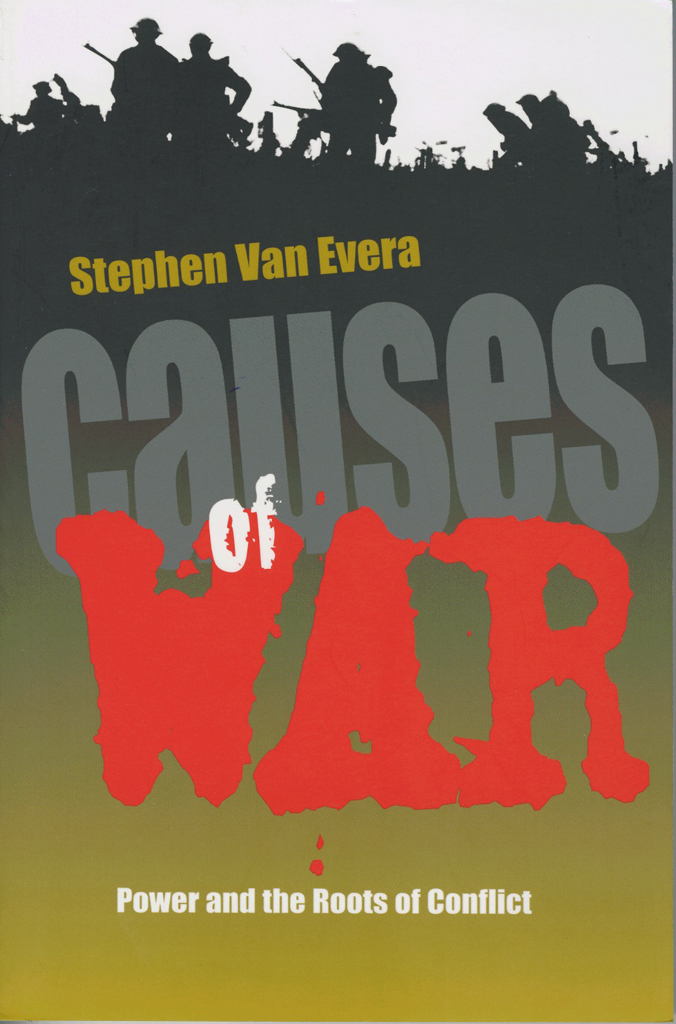
Causes of War What causes war? How can military conflicts best be prevented? In this book, Stephen Van Evera frames five conditions that increase the risk of interstate war. POLITICAL SCIENCE,Security (National & International)

Corporate Warriors Some have claimed that "War is too important to be left to the generals," but P. W. Singer asks "What about the business executives?" Breaking out of the guns-for-hire mold of traditional mercenaries, corporations now sell skills and services that... POLITICAL SCIENCE,Security (National & International)

China's Ascent This book offers multiple analytical perspectives—constructivist, liberal, neorealist—on the significance of the many dimensions of China's regional and global influence and considers the likelihood of conflict or peaceful accommodation. POLITICAL SCIENCE,Security (National & International)

Insider Threats High-security organizations around the world face devastating threats from insiders—trusted employees with access to sensitive information, facilities, and materials. From Edward Snowden to the Fort Hood shooter to the theft of nuclear materials, the threat from insiders is on the front page and at the top of the policy agenda. Insider Threats offers detailed case studies of insider disasters across a range of different types of institutions, from biological research laboratories, to nuclear power plants, to the U.S. Army. Matthew Bunn and Scott D. Sagan outline cognitive and organizational biases that lead organizations to downplay the insider threat, and they synthesize "worst practices" from these past mistakes, offering lessons that will be valuable for any organization with high security and a lot to lose. Insider threats pose dangers to anyone who handles information that is secret or proprietary, material that is highly valuable or hazardous, people who must be protected, or facilities that might be sabotaged. This is the first book to offer in-depth case studies across a range of industries and contexts, allowing entities such as nuclear facilities and casinos to learn from each other. It also offers an unprecedented analysis of terrorist thinking about using insiders to get fissile material or sabotage nuclear facilities. Contributors: Matthew Bunn, Harvard University; Andreas Hoelstad Dæhli, Oslo; Kathryn M. Glynn, IBM Global Business Services; Thomas Hegghammer, Norwegian Defence Research Establishment, Oslo; Austin Long, Columbia University; Scott D. Sagan, Stanford University; Ronald Schouten, Massachusetts General Hospital and Harvard Medical School; Jessica Stern, Harvard University; Amy B. Zegart, Stanford University POLITICAL SCIENCE,Security (National & International)

Unrivaled The United States has been the world's dominant power for more than a century. Now many analysts believe that other countries are rising and the United States is in decline. Is the unipolar moment over? Is America finished as a superpower? In this book, Michael Beckley argues that the United States has unique advantages over other nations that, if used wisely, will allow it to remain the world's sole superpower throughout this century. We are not living in a transitional, post-Cold War era. Instead, we are in the midst of what he calls the unipolar era—a period as singular and important as any epoch in modern history. This era, Beckley contends, will endure because the US has a much larger economic and military lead over its closest rival, China, than most people think and the best prospects of any nation to amass wealth and power in the decades ahead. Deeply researched and brilliantly argued, this book covers hundreds of years of great power politics and develops new methods for measuring power and predicting the rise and fall of nations. By documenting long-term trends in the global balance of power and explaining their implications for world politics, the book provides guidance for policymakers, businesspeople, and scholars alike. POLITICAL SCIENCE,Security (National & International)
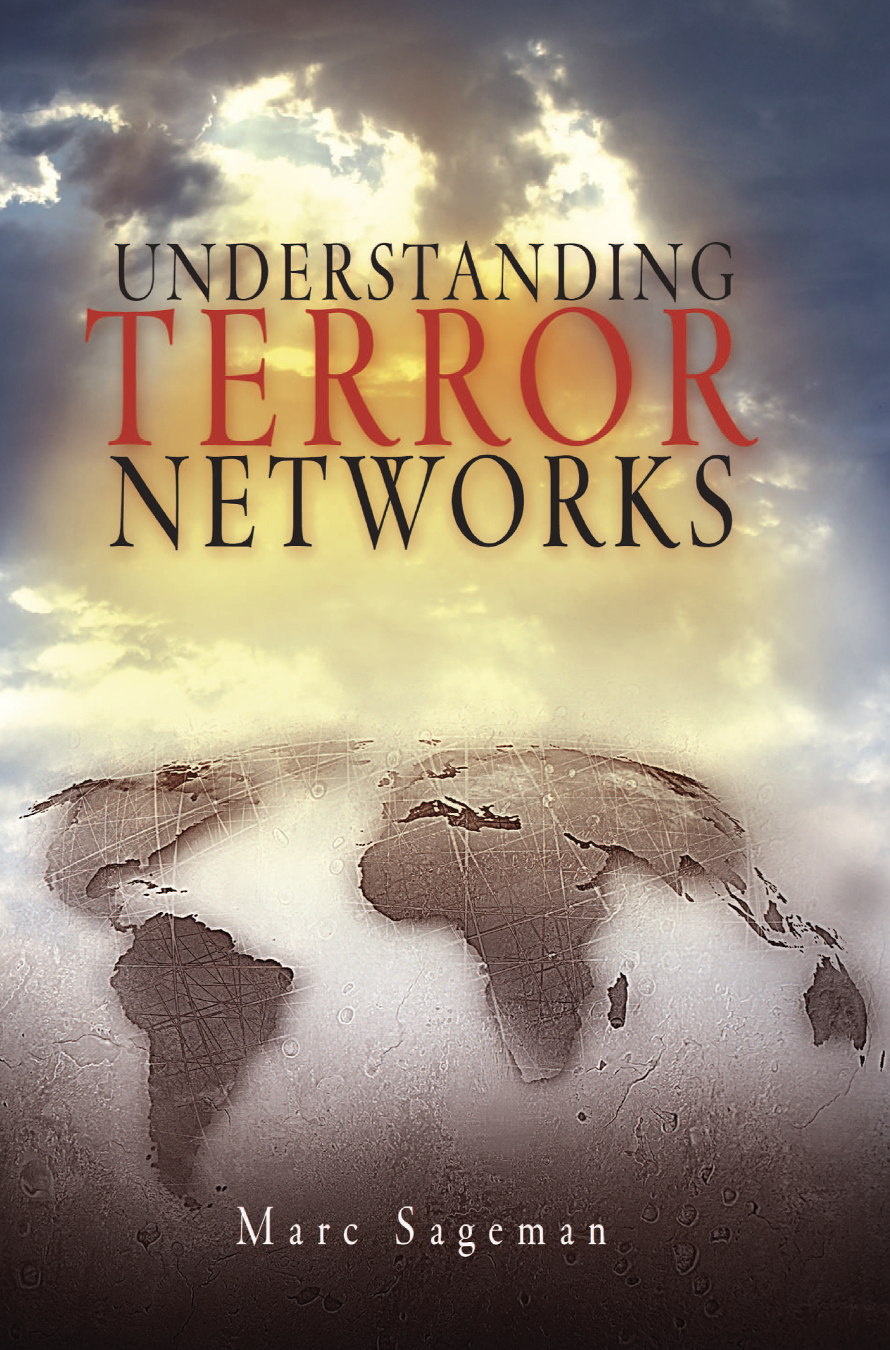
Understanding Terror Networks "In the late '80s, Sageman worked closely with Islamic fundamentalists during the Afghan-Soviet war and gained an intimate understanding of the development, form, and function of their networks. Sagemen wrote this book in order to dispel incorrect assertions about terrorist networks made by so-called experts."—Publishers Weekly POLITICAL SCIENCE,Security (National & International)

Misunderstanding Terrorism Misunderstanding Terrorism provides a striking reassessment of the scope and nature of the global neo-jihadi threat to the West. The post-9/11 decade experienced the emergence of new forms of political violence and new terrorist actors. More recently, Marc Sageman's understanding of how and why people have adopted fundamentalist ideologies and terrorist methods has evolved. Author of the classic Understanding Terror Networks, Sageman has become only more critical of the U.S. government's approach to the problem. He argues that U.S. society has been transformed for the worse by an extreme overreaction to a limited threat—limited, he insists, despite spectacular recent incidents, which he takes fully into account. Indeed, his discussion of just how limited the threat is marks a major contribution to the discussion and debate over the best way to a measured and much more effective response. POLITICAL SCIENCE,Security (National & International)

Winning the Next War Rosen argues that armies and navies are not forever doomed to "fight the last war." Rather, they are able to respond to shifts in the international strategic situation. POLITICAL SCIENCE,Security (National & International)
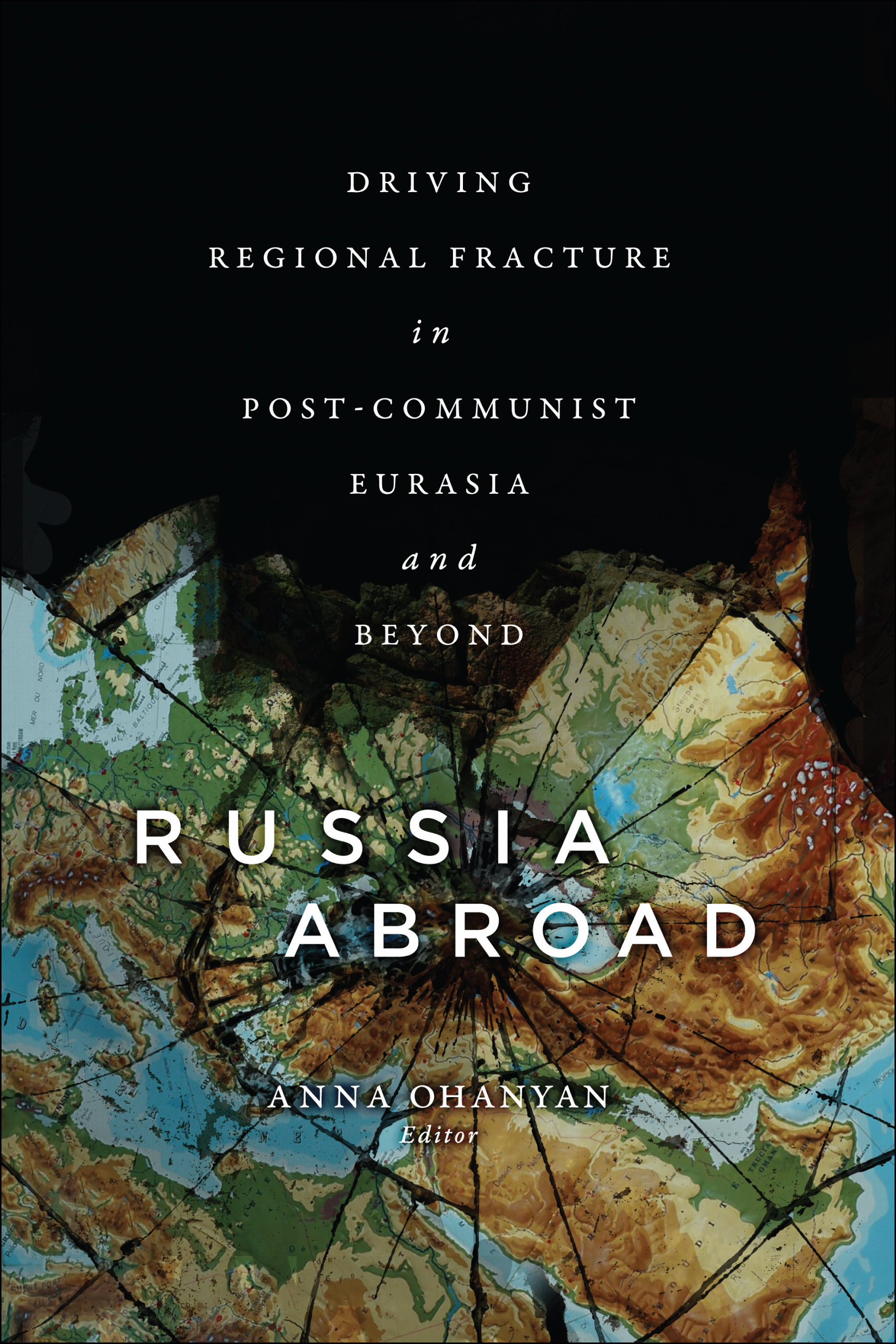
Russia Abroad Russia Abroad introduces a theory of regional fracture to explain how and why regions come apart and examines how Russia employs regional fracture as a strategy to keep states on its periphery in Eurasia and the Middle East weak and dependent. POLITICAL SCIENCE,Security (National & International)

Military Strategy, Joint Operations, and Airpower Military Strategy, Joint Operations, and Airpower will introduce readers to contemporary strategy and the operational level of war, particularly as it relates to airpower. This intermediate textbook was developed as required reading for all US Air Force Academy, and its contributors include both scholars and military practitioners. POLITICAL SCIENCE,Security (National & International)

Counterintelligence Theory and Practice This book provides all of the elements required for a successful counterintelligence operation from both an academic and a practitioner’s point of view. It offers an advanced understanding of the underlying theory and examines the challenges and practicalities of defensive and offensive counterintelligence. POLITICAL SCIENCE,Security (National & International)

Insurgent Women Why do women go to war? Despite the reality that female combatants exist the world over, we still know relatively little about who these women are, what motivates them to take up arms, how they are utilized by armed groups, and what happens to them when war ends. This book uses three case studies to explore variation in women’s participation in nonstate armed groups in a range of contemporary political and social contexts: the civil war in Ukraine, the conflicts involving Kurdish groups in the Middle East, and the civil war in Colombia. In particular, the authors examine three important aspects of women’s participation in armed groups: mobilization, participation in combat, and conflict cessation. In doing so, they shed light on women’s pathways into and out of nonstate armed groups. They also address the implications of women’s participation in these conflicts for policy, including postconflict programming. This is an accessible and timely work that will be a useful introduction to another side of contemporary conflict. POLITICAL SCIENCE,Security (National & International)
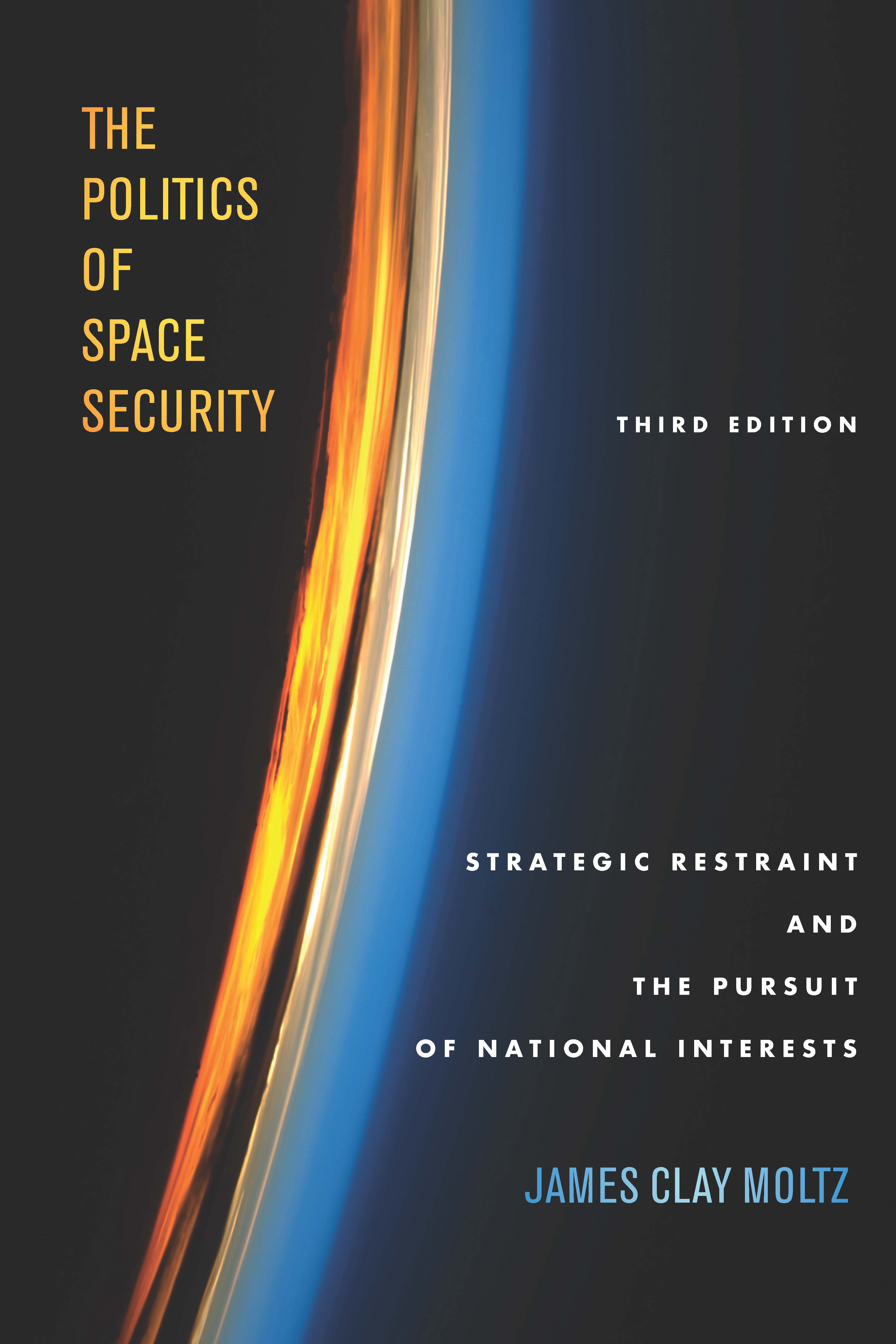
The Politics of Space Security For the past sixty years, countries have conducted military and civilian activities in space, often for competitive purposes. But they have not yet fought in this environment. This book examines the international politics of the space age from 1957 to the present, the reasons why strategic restraint emerged among the major military powers, and how recent trends toward weaponization may challenge prior norms of conflict avoidance. James Clay Moltz analyzes the competing demands of national interests in space against the shared interests of all spacefarers in preserving the safe use of space in the face of emerging threats, such as man-made orbital debris. This new edition offers analysis of the 2011 to 2018 period, including the second term of President Obama and the beginning of the Trump administration. Focusing on great power competition and cooperation, as well as questions related to the sustainability of current and future national space policies, The Politics of Space Security is an authoritative history of the space age. POLITICAL SCIENCE,Security (National & International)
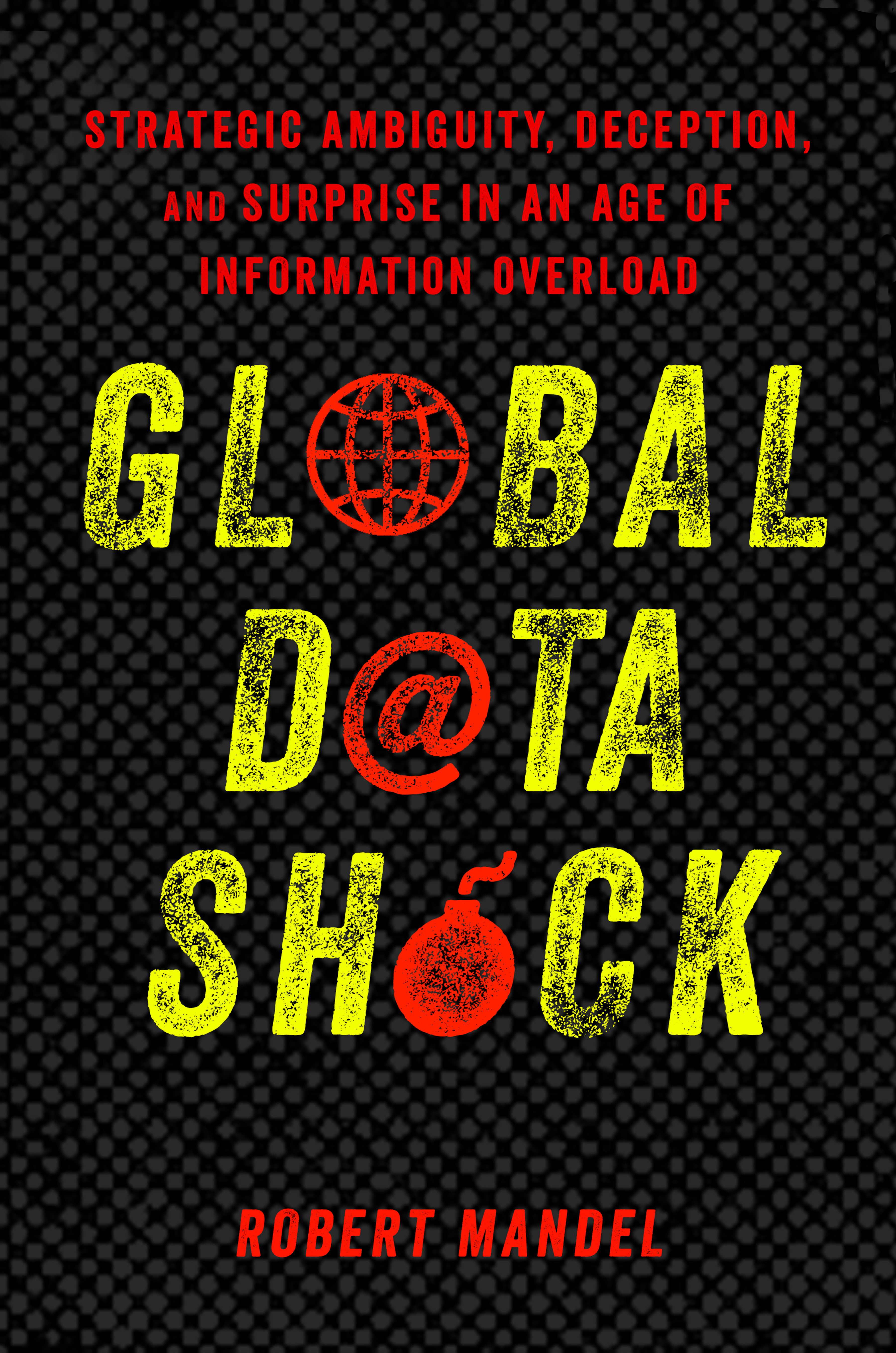
Global Data Shock Intelligence and security communities have access to an overwhelming amount of information. More data is better in an information-hungry world, but too much data paralyzes individual and institutional abilities to process and use information effectively. Robert Mandel calls this phenomenon "global data shock." He investigates how information overload affects strategic ambiguity, deception, and surprise, as well as the larger consequences for international security. This book provides not only an accessible framework for understanding global data shock and its consequences, but also a strategy to prepare for and respond to information overload. Global Data Shock explores how information overload facilitates deception, eroding international trust and cooperation in the post-Cold War era. A sweeping array of case studies illustrates the role of data shock in shaping global events from the 1990 Iraqi attack on Kuwait to Brexit. When strategists try to use an overabundance of data to their advantage, Mandel reveals, it often results in unanticipated and undesirable consequences. Too much information can lead to foreign intelligence failures, security policy incoherence, mass public frustrations, curtailment of democratic freedoms, and even international political anarchy. Global Data Shock addresses the pressing need for improved management of information and its strategic deployment. POLITICAL SCIENCE,Security (National & International)

Homeland Security, Third Edition The definitive guide to the homeland security enterprise―updated with critical changes in missions, tactics, and strategies International terrorists and rogue nations continue to threaten U.S. citizens, while domestic extremist groups seek to attack the American way of life and hackers take advantage of the Internet to inflict new types of havoc at work and home. Meanwhile, today’s human-made and natural disasters can impact communities on the scale of weapons of mass destruction. Given the range and intensity of today’s threats, we’re all on the front lines of national security. The most detailed and comprehensive work of its kind, Homeland Security: A Complete Guide provides insights to keep yourself, your family, your business, and your community safe from terrorism and disaster. Written by two global experts on domestic security, this new edition brings you up to date on the latest threats to U.S. security and the most effective methods for eliminating or mitigating them. Homeland Security: A Complete Guide, Third Edition has been expanded and revised to include: NEW insights on cyber security, Electro-Magnetic Pulse, and other emerging threatsNEW techniques and controversies, such metadata collection, surveillance by US intelligence agencies, drones, interrogation, and countering violent extremist programsNEW information about homegrown terrorism and radicalizationNEW content about ISIS and foreign fightersNEW information about controversial domestic extremist groups like AntiFa, BLM, and the AltRight This edition retains the critical information that has made it the go-to guide for leaders and concerned citizens alike—from the history of American homeland defense from the nation’s earliest days to the events of 9/11, from and the birth of the Department of Homeland Security to the emergence of today’s vast homeland security enterprise. With the important updates in this edition, you will be even better prepared for terrorism and disasters. POLITICAL SCIENCE,Security (National & International)

Surrogate Warfare Surrogate Warfare explores the emerging phenomenon of “surrogate warfare†in twenty-first century conflict. The popular notion of war is that it is fought en masse by the people of one side versus the other. But the reality today is that both state and non-state actors are increasingly looking to shift the burdens of war to surrogates. Surrogate warfare describes a patron's outsourcing of the strategic, operational, or tactical burdens of warfare, in whole or in part, to human and/or technological substitutes in order to minimize the costs of war. This phenomenon ranges from arming rebel groups, to the use of armed drones, to cyber propaganda. Krieg and Rickli bring old, related practices such as war by mercenary or proxy under this new overarching concept. Apart from analyzing the underlying sociopolitical drivers that trigger patrons to substitute or supplement military action, this book looks at the intrinsic trade-offs between substitutions and control that shapes the relationship between patron and surrogate. Surrogate Warfare will be essential reading for anyone studying contemporary conflict. POLITICAL SCIENCE,Security (National & International)
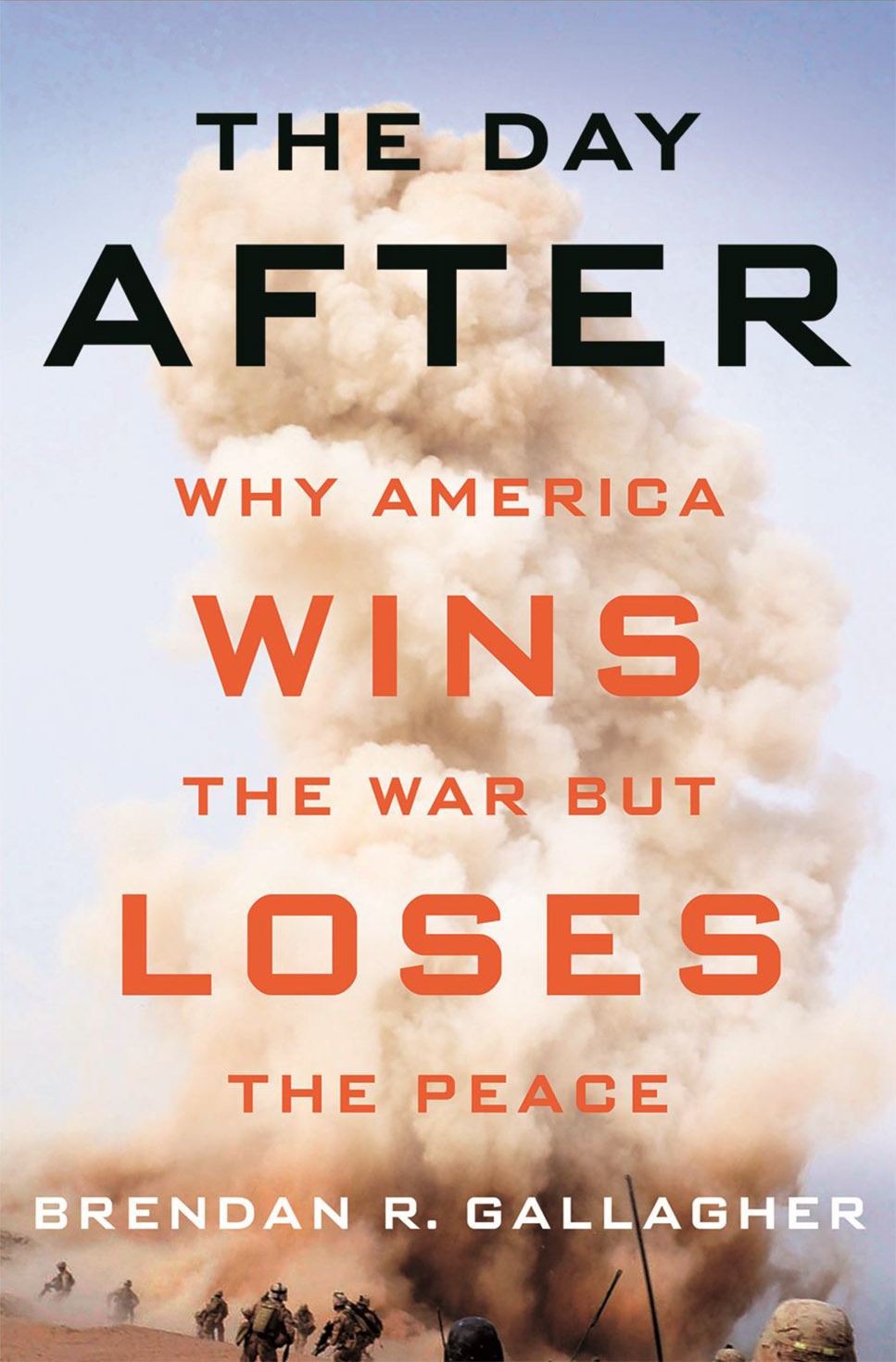
The Day After Since 9/11, why have we won smashing battlefield victories only to botch nearly everything that comes next? In the opening phases of war in Afghanistan, Iraq, and Libya, we mopped the floor with our enemies. But in short order, things went horribly wrong. We soon discovered we had no coherent plan to manage the "day after." The ensuing debacles had truly staggering consequences—many thousands of lives lost, trillions of dollars squandered, and the apparent discrediting of our foreign policy establishment. This helped set the stage for an extraordinary historical moment in which America's role in the world, along with our commitment to democracy at home and abroad, have become subject to growing doubt. With the benefit of hindsight, can we discern what went wrong? Why have we had such great difficulty planning for the aftermath of war? In The Day After, Brendan Gallagher—an Army lieutenant colonel with multiple combat tours to Iraq and Afghanistan, and a Princeton Ph.D.—seeks to tackle this vital question. Gallagher argues there is a tension between our desire to create a new democracy and our competing desire to pull out as soon as possible. Our leaders often strive to accomplish both to keep everyone happy. But by avoiding the tough underlying decisions, it fosters an incoherent strategy. This makes chaos more likely. The Day After draws on new interviews with dozens of civilian and military officials, ranging from US cabinet secretaries to four-star generals. It also sheds light on how, in Kosovo, we lowered our postwar aims to quietly achieve a surprising partial success. Striking at the heart of what went wrong in our recent wars, and what we should do about it, Gallagher asks whether we will learn from our mistakes, or provoke even more disasters? Human lives, money, elections, and America's place in the world may hinge on the answer. POLITICAL SCIENCE,Security (National & International)

Mindf*ck For the first time, the Cambridge Analytica whistleblower tells the inside story of the data mining and psychological manipulation behind the election of Donald Trump and the Brexit referendum, connecting Facebook, WikiLeaks, Russian intelligence, and international hackers. “Mindf*ck demonstrates how digital influence operations, when they converged with the nasty business of politics, managed to hollow out democracies.”—The Washington Post Mindf*ck goes deep inside Cambridge Analytica’s “American operations,” which were driven by Steve Bannon’s vision to remake America and fueled by mysterious billionaire Robert Mercer’s money, as it weaponized and wielded the massive store of data it had harvested on individuals—in excess of 87 million—to disunite the United States and set Americans against each other. Bannon had long sensed that deep within America’s soul lurked an explosive tension. Cambridge Analytica had the data to prove it, and in 2016 Bannon had a presidential campaign to use as his proving ground. Christopher Wylie might have seemed an unlikely figure to be at the center of such an operation. Canadian and liberal in his politics, he was only twenty-four when he got a job with a London firm that worked with the U.K. Ministry of Defense and was charged putatively with helping to build a team of data scientists to create new tools to identify and combat radical extremism online. In short order, those same military tools were turned to political purposes, and Cambridge Analytica was born. Wylie’s decision to become a whistleblower prompted the largest data-crime investigation in history. His story is both exposé and dire warning about a sudden problem born of very new and powerful capabilities. It has not only laid bare the profound vulnerabilities—and profound carelessness—in the enormous companies that drive the attention economy, it has also exposed the profound vulnerabilities of democracy itself. What happened in 2016 was just a trial run. Ruthless actors are coming for your data, and they want to control what you think. POLITICAL SCIENCE,Security (National & International)
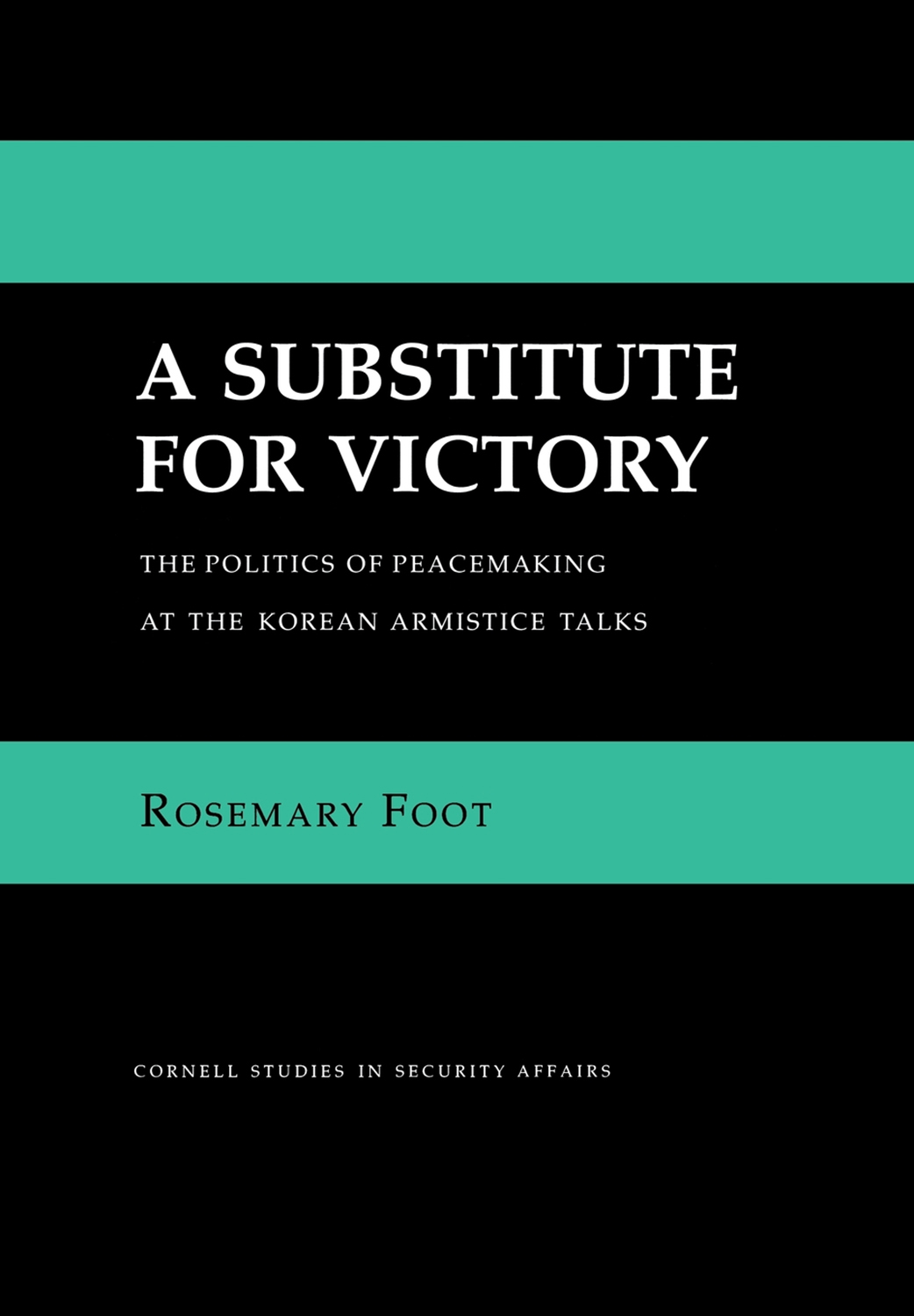
A Substitute for Victory After more than two years of bitter negotiations during which combatants & civilians continued to suffer casualties, the Korean armistice was concluded in July 1953. Focusing on the Americans formulation of negotiating positions & on their attempts to coordinate political goals with military tactics, Rosemary Foot here charts the tortuous path to peace & offers a new explanation for the agonizing length of the talks. She also takes into account the role of the Western allies & the Indian, South Korean, North Korean, & Chinese governments as she examines the complex international setting in which the armistice took place. POLITICAL SCIENCE,Security (National & International)

Full Spectrum Dominance America's war on terror is widely defined by the Afghanistan and Iraq fronts. Yet, as this book demonstrates, both the international campaign and the new ways of fighting that grew out of it played out across multiple fronts beyond the Middle East. Maria Ryan explores how secondary fronts in the Philippines, sub-Saharan Africa, Georgia, and the Caspian Sea Basin became key test sites for developing what the Department of Defense called "full spectrum dominance": mastery across the entire range of possible conflict, from conventional through irregular warfare. Full Spectrum Dominance is the first sustained historical examination of the secondary fronts in the war on terror. It explores whether irregular warfare has been effective in creating global stability or if new terrorist groups have emerged in response to the intervention. As the U.S. military, Department of Defense, White House, and State Department have increasingly turned to irregular capabilities and objectives, understanding the underlying causes as well as the effects of the quest for full spectrum dominance become ever more important. The development of irregular strategies has left a deeply ambiguous and concerning global legacy. POLITICAL SCIENCE,Security (National & International)

The Madman Theory From praising dictators to alienating allies, Trump has made chaos his calling card. Has his strategy caused more problems than it solved? Richard Nixon tried it first. Hoping to make communist bloc countries uneasy and thus unstable, Nixon let them think he was just crazy enough to nuke them. He called this “the madman theory.†Nearly half a century later, President Trump has employed his own “madman theory,†sometimes intentionally and sometimes not.Trump praises Kim Jong-un and their “love notes,†admires and flatters Vladimir Putin, and gives a greenlight to Recep Tayyip Erdogan to invade Syria. Meanwhile, he attacks US institutions and officials, ignores his own advisors, and turns his back on US allies from Canada and Mexico to NATO to Ukraine to the Kurds at war with ISIS. Trump is willing to make the nation’s most sensitive and consequential decisions while often ignoring the best information and intelligence available to him. He continually catches the world off guard, but is it working? In The Madman Theory, Jim Sciutto shows how Trump's supporters assume he has a strategy for long-term success – that he is somehow playing three-dimensional chess. Now that we are four years into his presidency, we can see his unpredictable focus on short-term headlines has in fact lead to predictably mediocre results in the short and long run. Trump’s foreign policy has undermined American values and national security interests, while hurting allies who have been on our side for decades, leaving them isolated and vulnerable without American support. Meanwhile, he comforts and emboldens our enemies. The White House’s revolving door of staff demonstrates that Trump has no real plan; all serious policymakers—and those who would be a check on his most destructive impulses—have been exiled or jumped ship. Sciutto has interviewed a wide swath of current and former administration officials to assemble the first comprehensive portrait of the impact of Trump’s erratic foreign policy. Smart, authoritative, and compelling, The Madman Theory is the definitive take on Trump’s calamitous legacy around the globe, showing how his proclivity for chaos is creating a world which is more unstable, violent, and impoverished than it was before. POLITICAL SCIENCE,Security (National & International)

Dangerous Decade Taiwan’s position looks increasingly precarious, and tensions threaten to grow into a major strategic crisis. Chinese President Xi Jinping has made reunification with Taiwan a central pillar of his vision for China, and has ramped up diplomatic and economic pressure on Taiwan. Its inhabitants are increasingly estranged from the mainland, and Tsai Ing-wen’s administration refuses to conduct relations with China on Beijing’s terms. Taiwan could take on renewed strategic significance amid the backdrop of the deepening rivalry between China and the United States, and find itself at the centre of a Cold War-style superpower confrontation. While Washington’s support and military power has historically guaranteed Taiwan’s security, this is no longer a certainty. This Adelphi book argues that China’s military modernisation has changed the cross-strait military balance, and the ability of the US to prevail in a conflict over Taiwan may have evaporated by 2030. As China feels increasingly empowered to retake Taiwan, there is significant potential for escalation, particularly given the ambiguity of Beijing’s ‘red lines’ on Taiwan. Neither Beijing, Taipei nor Washington want such a conflict, but each is challenging the uneasy status quo. Taylor calls for the introduction of a narrower set of formal crisis-management mechanisms designed to navigate a major Taiwan crisis. POLITICAL SCIENCE,Security (National & International)
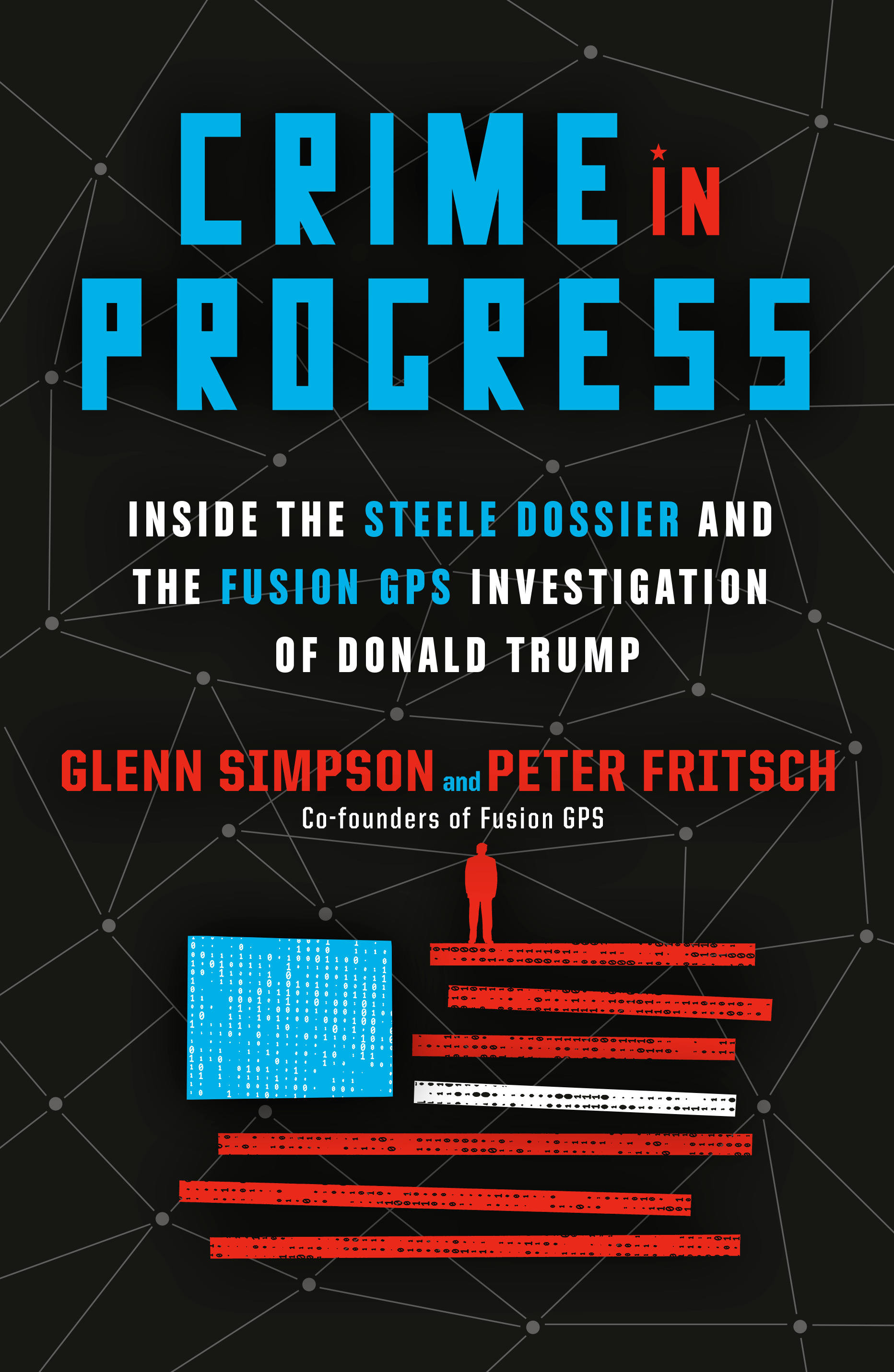
Crime in Progress #1 NEW YORK TIMES BESTSELLER • “I’ve read kind of all the books on this subject . . . and this is the one you want to read.”—Rachel Maddow Before Ukraine, before impeachment: This is the never-before-told inside story of the high-stakes, four-year-long investigation into Donald Trump’s Russia ties—culminating in the Steele dossier, and sparking the Mueller report—from the founders of political opposition research company Fusion GPS. Fusion GPS was founded in 2010 by Glenn Simpson and Peter Fritsch, two former reporters at The Wall Street Journal who decided to abandon the struggling news business and use their reporting skills to conduct open-source investigations for businesses and law firms—and opposition research for political candidates. In the fall of 2015, they were hired to look into the finances of Donald Trump. What began as a march through a mind-boggling trove of lawsuits, bankruptcies, and sketchy overseas projects soon took a darker turn: The deeper Fusion dug, the more it began to notice names that Simpson and Fritsch had come across during their days covering Russian corruption—and the clearer it became that the focus of Fusion’s research going forward would be Trump’s entanglements with Russia. To help them make sense of what they were seeing, Simpson and Fritsch engaged the services of a former British intelligence agent and Russia expert named Christopher Steele. He would produce a series of memos—which collectively became known as the Steele dossier—that raised deeply alarming questions about the nature of Trump’s ties to a hostile foreign power. Those memos made their way to U.S. intelligence agencies, and then to President Barack Obama and President-elect Trump. On January 10, 2017, the Steele dossier broke into public view, and the Trump-Russia story reached escape velocity. At the time, Fusion GPS was just a ten-person consulting firm tucked away above a Starbucks near Dupont Circle, but it would soon be thrust into the center of the biggest news story on the planet—a story that would lead to accusations of witch hunts, a relentless campaign of persecution by congressional Republicans, bizarre conspiracy theories, lawsuits by Russian oligarchs, and the Mueller report. In Crime in Progress, Simpson and Fritsch tell their story for the first time—a tale of the high-stakes pursuit of one of the biggest, most important stories of our time—no matter the costs. POLITICAL SCIENCE,Security (National & International)

Information Technology and Military Power Militaries with state-of-the-art information technology sometimes bog down in confusing conflicts. To understand why, it is important to understand the micro-foundations of military power in the information age, and this is exactly what Jon R. Lindsay's Information Technology and Military Power gives us. As Lindsay shows, digital systems now mediate almost every effort to gather, store, display, analyze, and communicate information in military organizations. He highlights how personnel now struggle with their own information systems as much as with the enemy. Throughout this foray into networked technology in military operations, we see how information practice—the ways in which practitioners use technology in actual operations—shapes the effectiveness of military performance. The quality of information practice depends on the interaction between strategic problems and organizational solutions. Information Technology and Military Power explores information practice through a series of detailed historical cases and ethnographic studies of military organizations at war. Lindsay explains why the US military, despite all its technological advantages, has struggled for so long in unconventional conflicts against weaker adversaries. This same perspective suggests that the US retains important advantages against advanced competitors like China that are less prepared to cope with the complexity of information systems in wartime. Lindsay argues convincingly that a better understanding of how personnel actually use technology can inform the design of command and control, improve the net assessment of military power, and promote reforms to improve military performance. Warfighting problems and technical solutions keep on changing, but information practice is always stuck in between. POLITICAL SCIENCE,Security (National & International)

Why Containment Works Why Containment Works examines the conduct of American foreign policy during and after the Cold War through the lens of applied policy analysis. Wallace J. Thies argues that the Bush Doctrine after 2002 was a theory of victory—a coherent strategic view that tells a state how best to transform scarce resources into useful military assets, and how to employ those assets in conflicts. He contrasts prescriptions derived from the Bush Doctrine with an alternative theory of victory, one based on containment and deterrence, which US presidents employed for much of the Cold War period. There are, he suggests, multiple reasons for believing that containment was working well against Saddam Hussein's Iraq after the first Gulf War and that there was no need to invade Iraq in 2003. Thies reexamines five cases of containment drawn from the Cold War and the post-Cold War world. Each example, Thies suggests, offered US officials a choice between reliance on traditional notions of containment and reliance on a more forceful approach. To what extent did reliance on rival theories of victory—containment versus first strike—contribute to a successful outcome? Might these cases have been resolved more quickly, at lower cost, and more favorably to American interests if US officials had chosen a different mix of the coercive and deterrent tools available to them? Thies suggests that the conventional wisdom about containment was often wrong: a superpower like the United States has such vast resources at its disposal that it could easily thwart Libya, Iraq, and Iran by means other than open war. POLITICAL SCIENCE,Security (National & International)
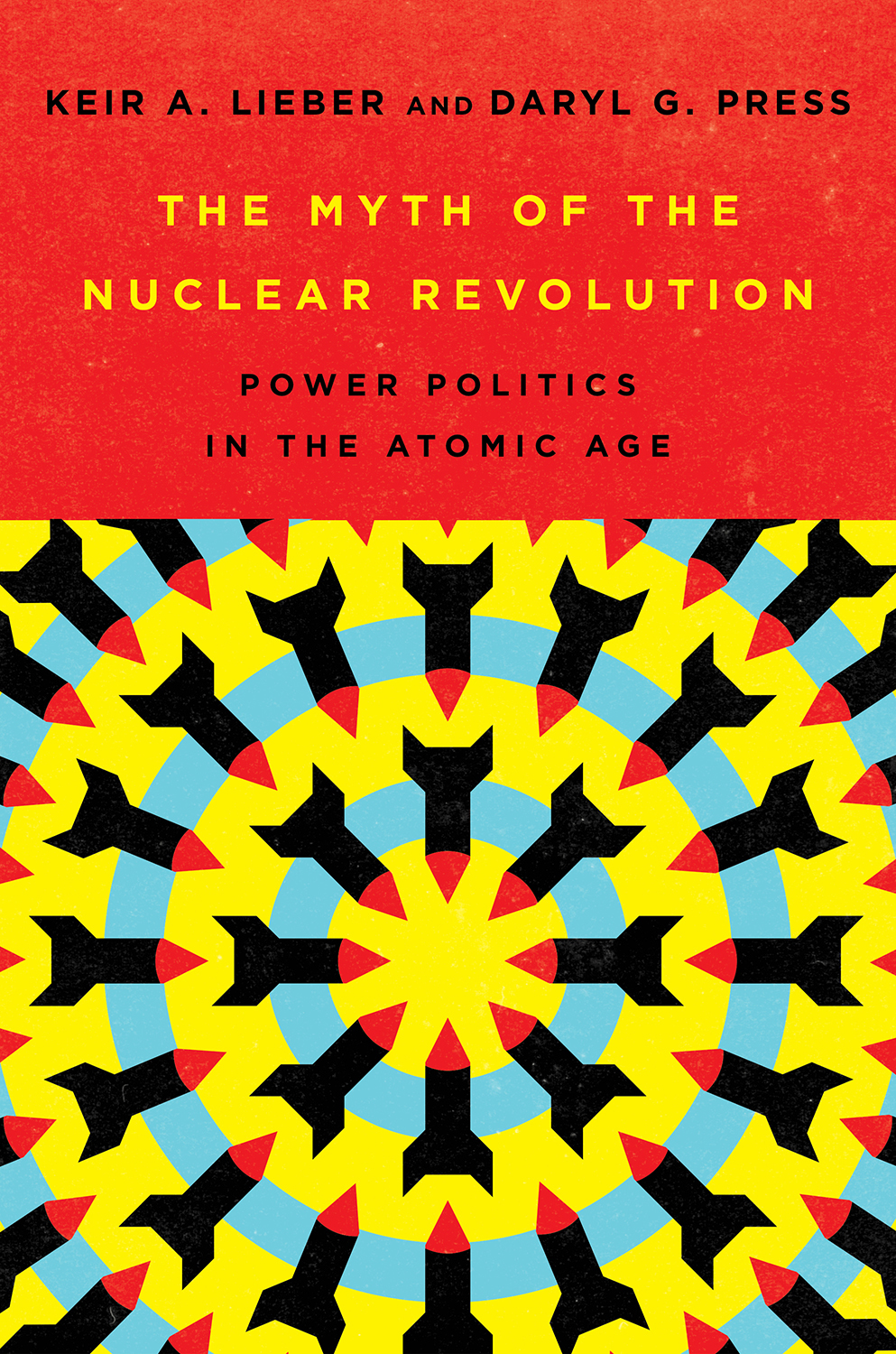
The Myth of the Nuclear Revolution Leading analysts have predicted for decades that nuclear weapons would help pacify international politics. The core notion is that countries protected by these fearsome weapons can stop competing so intensely with their adversaries: they can end their arms races, scale back their alliances, and stop jockeying for strategic territory. But rarely have theory and practice been so opposed. Why do international relations in the nuclear age remain so competitive? Indeed, why are today's major geopolitical rivalries intensifying? In The Myth of the Nuclear Revolution, Keir A. Lieber and Daryl G. Press tackle the central puzzle of the nuclear age: the persistence of intense geopolitical competition in the shadow of nuclear weapons. They explain why the Cold War superpowers raced so feverishly against each other; why the creation of "mutual assured destruction" does not ensure peace; and why the rapid technological changes of the 21st century will weaken deterrence in critical hotspots around the world. By explaining how the nuclear revolution falls short, Lieber and Press discover answers to the most pressing questions about deterrence in the coming decades: how much capability is required for a reliable nuclear deterrent, how conventional conflicts may become nuclear wars, and how great care is required now to prevent new technology from ushering in an age of nuclear instability. POLITICAL SCIENCE,Security (National & International)

Beyond 9/11 Drawing on two decades of government efforts to "secure the homeland," experts offer crucial strategic lessons and detailed recommendations for homeland security. For Americans, the terrorist attacks of September 11, 2001, crystallized the notion of homeland security. But what does it mean to "secure the homeland" in the twenty-first century? What lessons can be drawn from the first two decades of U.S. government efforts to do so? In Beyond 9/11, leading academic experts and former senior government officials address the most salient challenges of homeland security today. POLITICAL SCIENCE,Security (National & International)
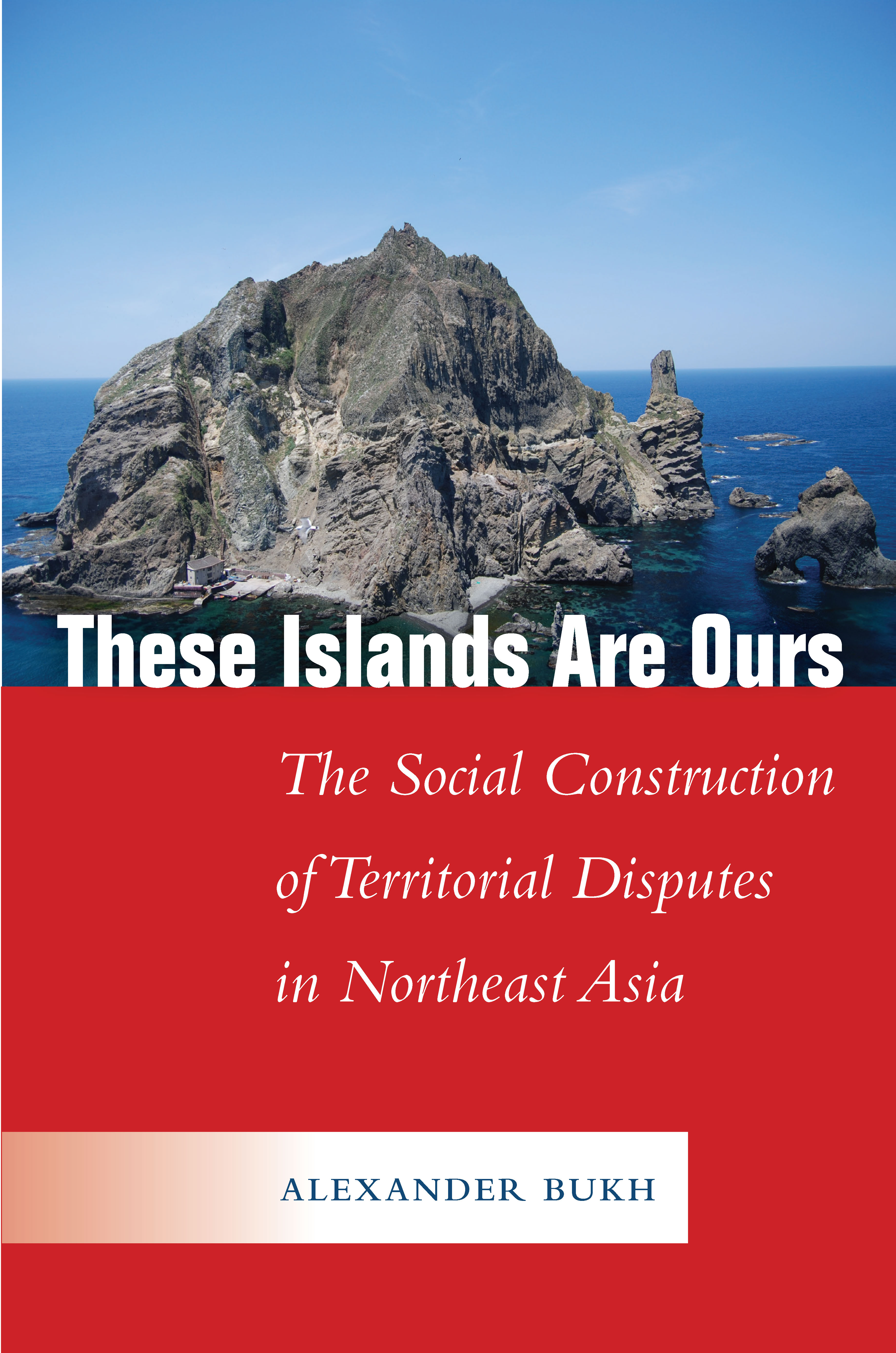
These Islands Are Ours Territorial disputes are one of the main sources of tension in Northeast Asia. Escalation in such conflicts often stems from a widely shared public perception that the territory in question is of the utmost importance to the nation. While that's frequently not true in economic, military, or political terms, citizens' groups and other domestic actors throughout the region have mounted sustained campaigns to protect or recover disputed islands. Quite often, these campaigns have wide-ranging domestic and international consequences. Why and how do territorial disputes that at one point mattered little, become salient? Focusing on non-state actors rather than political elites, Alexander Bukh explains how and why apparently inconsequential territories become central to national discourse in Japan, South Korea, and Taiwan. These Islands Are Ours challenges the conventional wisdom that disputes-related campaigns originate in the desire to protect national territory and traces their roots to times of crisis in the respective societies. This book gives us a new way to understand the nature of territorial disputes and how they inform national identities by exploring the processes of their social construction, and amplification. POLITICAL SCIENCE,Security (National & International)

Introduction to Conflict Resolution This introductory course text explores the genealogy of the field of conflict resolution by examining three different epochs of the field, each one tied to the historical context and events of the day. POLITICAL SCIENCE,Security (National & International)
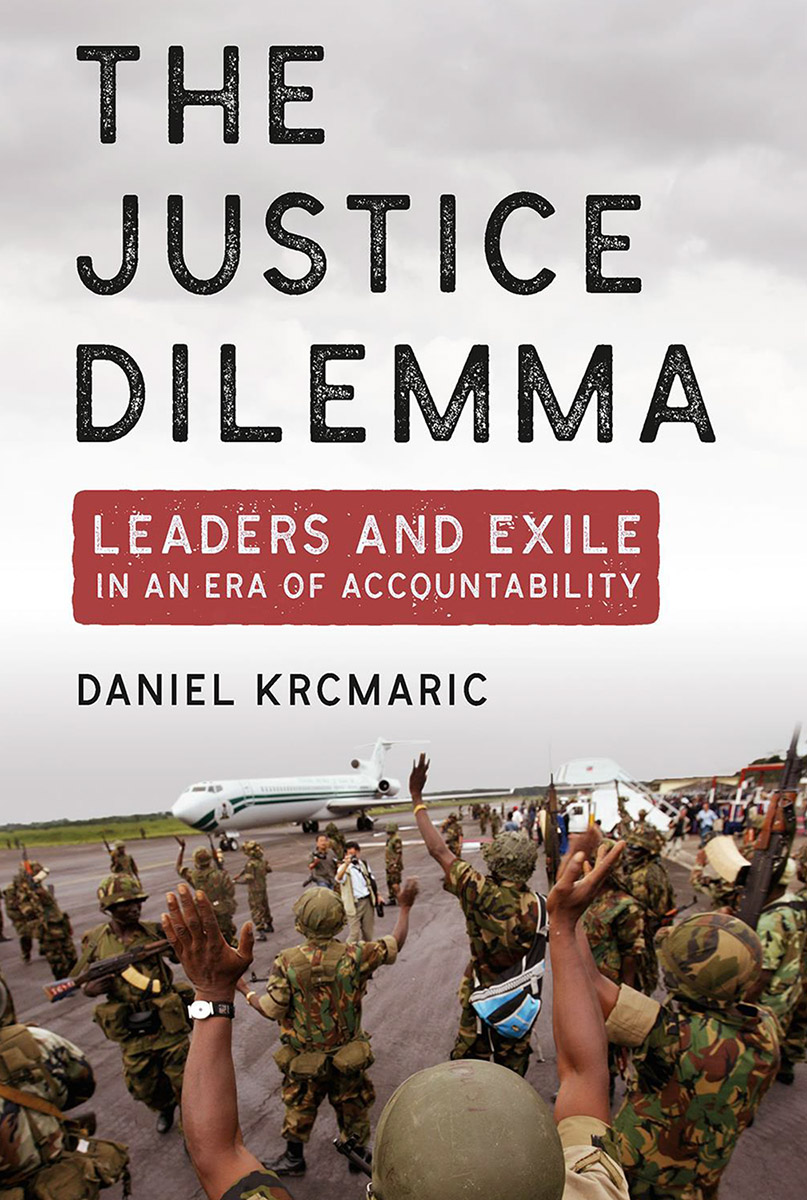
The Justice Dilemma Abusive leaders are now held accountable for their crimes in a way that was unimaginable just a few decades ago. What are the consequences of this recent push for international justice? In The Justice Dilemma, Daniel Krcmaric explains why the "golden parachute" of exile is no longer an attractive retirement option for oppressive rulers. He argues that this is both a blessing and a curse: leaders culpable for atrocity crimes fight longer civil wars because they lack good exit options, but the threat of international prosecution deters some leaders from committing atrocities in the first place. The Justice Dilemma therefore diagnoses an inherent tension between conflict resolution and atrocity prevention, two of the signature goals of the international community. Krcmaric also sheds light on several important puzzles in world politics. Why do some rulers choose to fight until they are killed or captured? Why not simply save oneself by going into exile? Why do some civil conflicts last so much longer than others? Why has state-sponsored violence against civilians fallen in recent years? While exploring these questions, Krcmaric marshals statistical evidence on patterns of exile, civil war duration, and mass atrocity onset. He also reconstructs the decision-making processes of embattled leaders—including Muammar Gaddafi of Libya, Charles Taylor of Liberia, and Blaise Compaoré of Burkina Faso—to show how contemporary international justice both deters atrocities and prolongs conflicts. POLITICAL SCIENCE,Security (National & International)
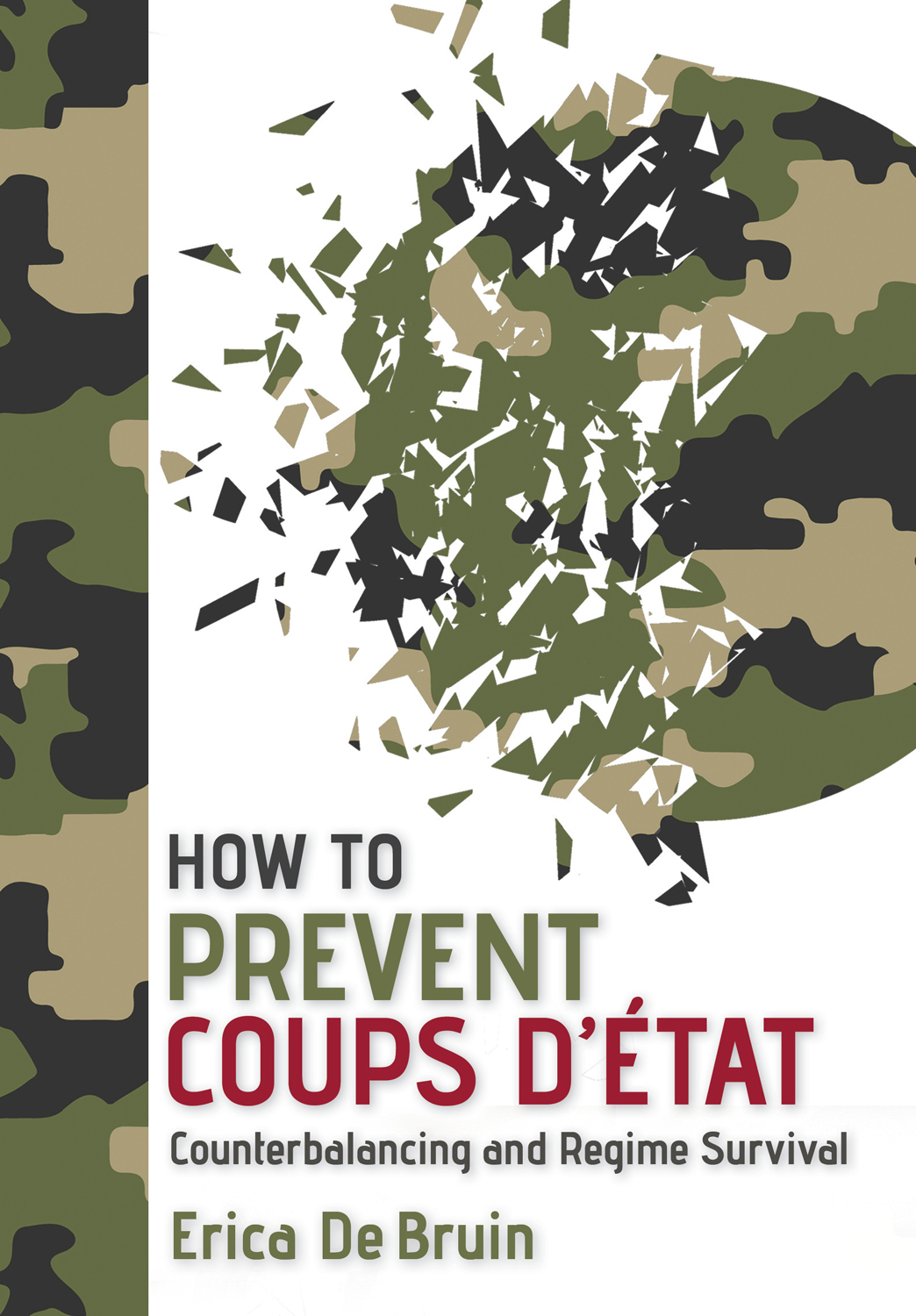
How to Prevent Coups d'État In this lively and provocative book, Erica De Bruin looks at the threats that rulers face from their own armed forces. Can they make their regimes impervious to coups? How to Prevent Coups d'État shows that how leaders organize their coercive institutions has a profound effect on the survival of their regimes. When rulers use presidential guards, militarized police, and militia to counterbalance the regular military, efforts to oust them from power via coups d'état are less likely to succeed. Even as counterbalancing helps to prevent successful interventions, however, the resentment that it generates within the regular military can provoke new coup attempts. And because counterbalancing changes how soldiers and police perceive the costs and benefits of a successful overthrow, it can create incentives for protracted fighting that result in the escalation of a coup into full-blown civil war. Drawing on an original dataset of state security forces in 110 countries over a span of fifty years, as well as case studies of coup attempts in Asia, Africa, Latin America, and the Middle East, De Bruin sheds light on how counterbalancing affects regime survival. Understanding the dynamics of counterbalancing, she shows, can help analysts predict when coups will occur, whether they will succeed, and how violent they are likely to be. The arguments and evidence in this book suggest that while counterbalancing may prevent successful coups, it is a risky strategy to pursue—and one that may weaken regimes in the long term. POLITICAL SCIENCE,Security (National & International)
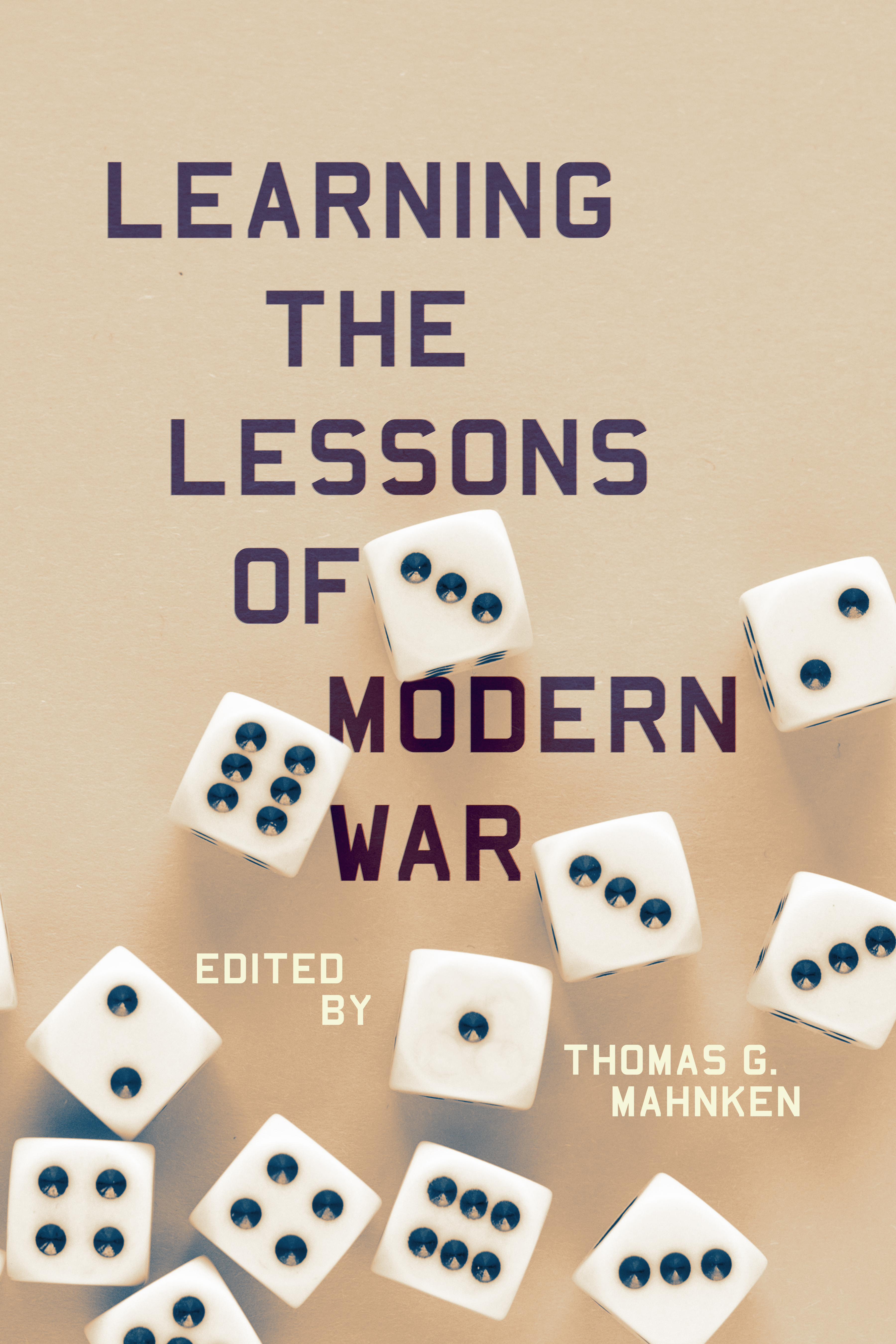
Learning the Lessons of Modern War This book explores the lessons of recent wars as a way to understand continuity and change in the conduct of war. POLITICAL SCIENCE,Security (National & International)
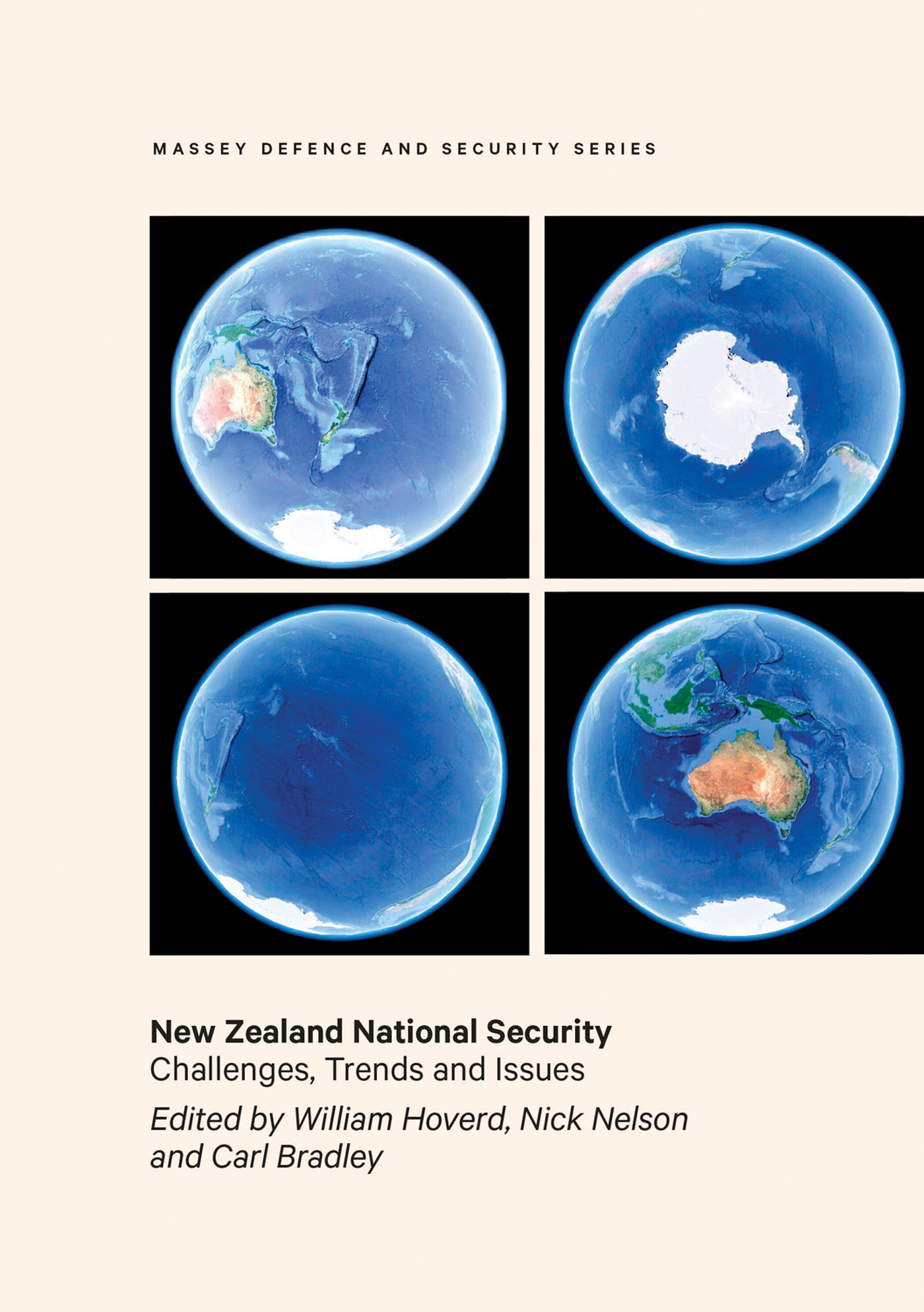
New Zealand National Security In an interrelated and increasingly complex, dynamic and globalised security environment, New Zealand faces a range of complex and multifaceted non-traditional threats. They range from trade insecurity to terrorism and transnational crime, disputes over the control and exploitation of resources, and tensions linked to ideological, cultural and religious differences. The volume's contributors include local and international academics alongside experts who have extensive New Zealand security-sector expertise in defence, diplomacy, national security coordination, intelligence, policing, trade security and bordermanagement.New Zealand National Security: Challenges, Trends and Issues situates New Zealand within its broader political and regional security context and the various great and minor power tensions occurring within the Asia Pacific and South Pacific regions. It looks at how to protect New Zealand's border and the zones where its interests meet the world; it examines alternative ways of thinking and doing New Zealand's national security; and it looks at looming national security questions. It aims to provide New Zealanders with a critical awareness of the various salient security trends, challenges and opportunities to initiate a ‘whole of society' discussion of security. POLITICAL SCIENCE,Security (National & International)

Patterns of Conventional Warfighting under the Nuclear Umbrella This book explores how nuclear weapons influence conventional warfighting, through three case studies of countries not party to the Non-Proliferation Treaty: Pakistan, India, and Israel. The author examines how decision makers choose a preferred pattern of war management, as well as how these choices affect conflicts, suggesting that nuclear weaponization constitutes a clear change in the relative power of countries. This distribution of power within the international system expands or reduces the selection of strategies or war management patterns available to members of the international community. However, historic traumatic events like military defeats, countries’ self-images, and images of enemies form the perceptions of decision makers regarding material power and change thereof, suggesting that choices of decision makers are not affected directly by changes in relative power relations, but rather through an intermediate level of strategic culture parameter. POLITICAL SCIENCE,Security (National & International)
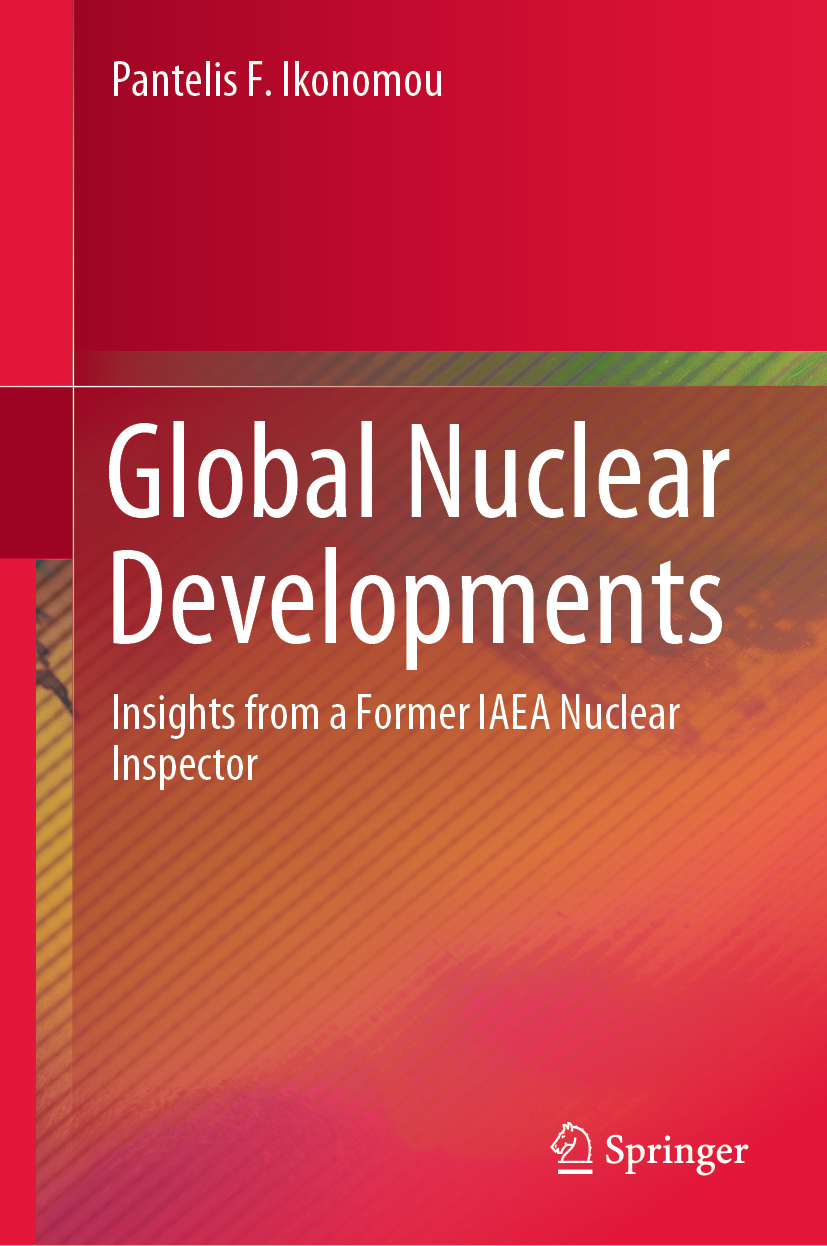
Global Nuclear Developments Written by a former International Atomic Energy Agency (IAEA) nuclear inspector and nuclear security expert, this book provides a comprehensive and authentic overview of current global nuclear developments. The author provides detailed insights into current and past nuclear crises and reveals the technical capabilities, political strategies and motives of nuclear weapon owners. By analyzing the nuclear programs and strategies of various countries, including the USA, Russia, China, Great Britain and France, this book highlights the existing global nuclear threat and the risks it entails for humanity. It also describes the current blockades and suggests possible ways out. Given its scope, the book will appeal to scholars and policymakers interested in gaining new insights into sensitive or complex nuclear programs in various countries. POLITICAL SCIENCE,Security (National & International)
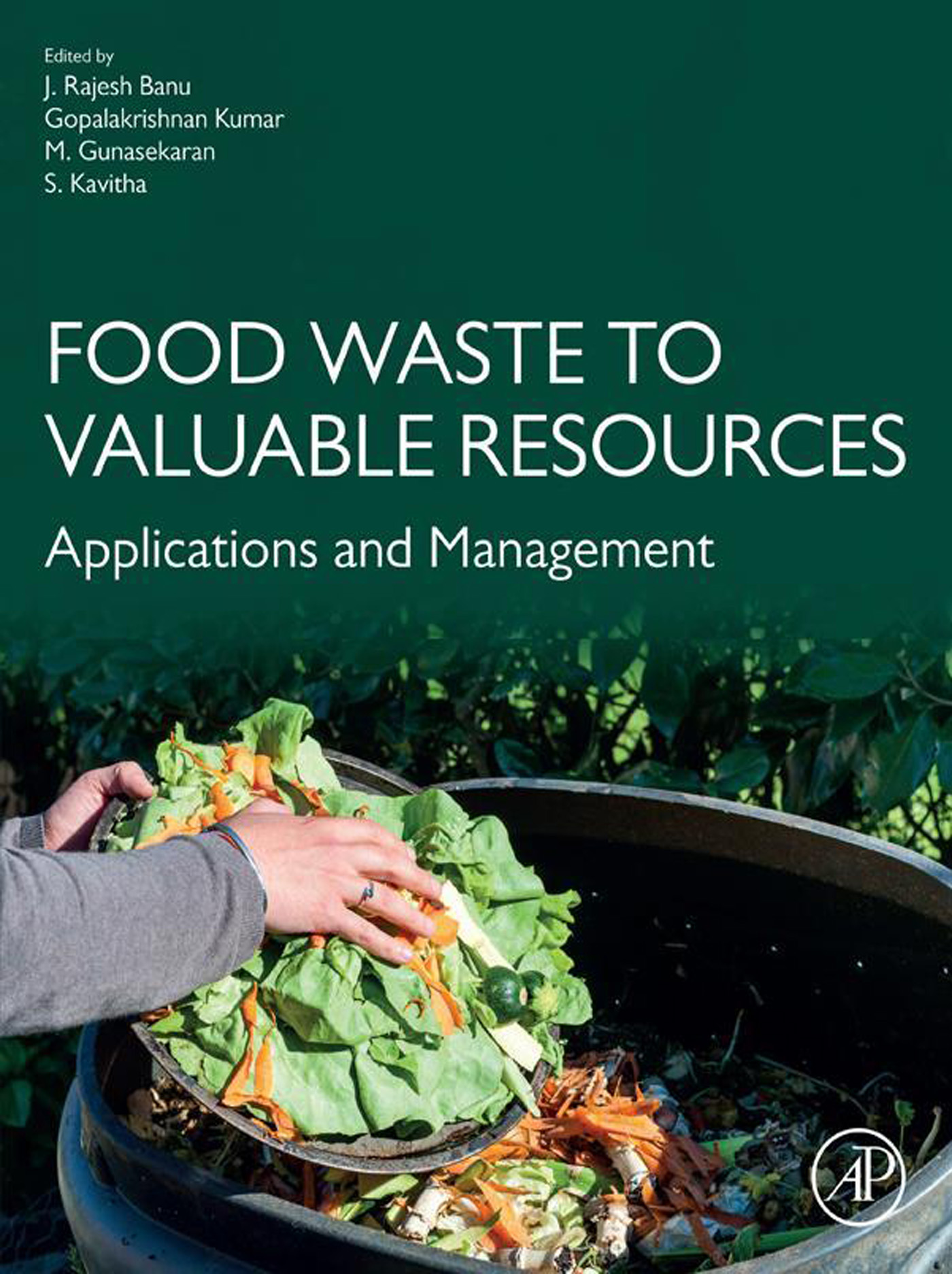
Food Waste to Valuable Resources Food Waste to Valuable Resources: Applications and Management compiles current information pertaining to food waste, placing particular emphasis on the themes of food waste management, biorefineries, valuable specialty products and technoeconomic analysis. Following its introduction, this book explores new valuable resource technologies, the bioeconomy, the technoeconomical evaluation of food-waste-based biorefineries, and the policies and regulations related to a food-waste-based economy. It is an ideal reference for researchers and industry professionals working in the areas of food waste valorization, food science and technology, food producers, policymakers and NGOs, environmental technologists, environmental engineers, and students studying environmental engineering, food science, and more. Presents recent advances, trends and challenges related to food waste valorization Contains invaluable knowledge on of food waste management, biorefineries, valuable specialty products and technoeconomic analysis Highlights modern advances and applications of food waste bioresources in various products’ recovery POLITICAL SCIENCE,Security (National & International)
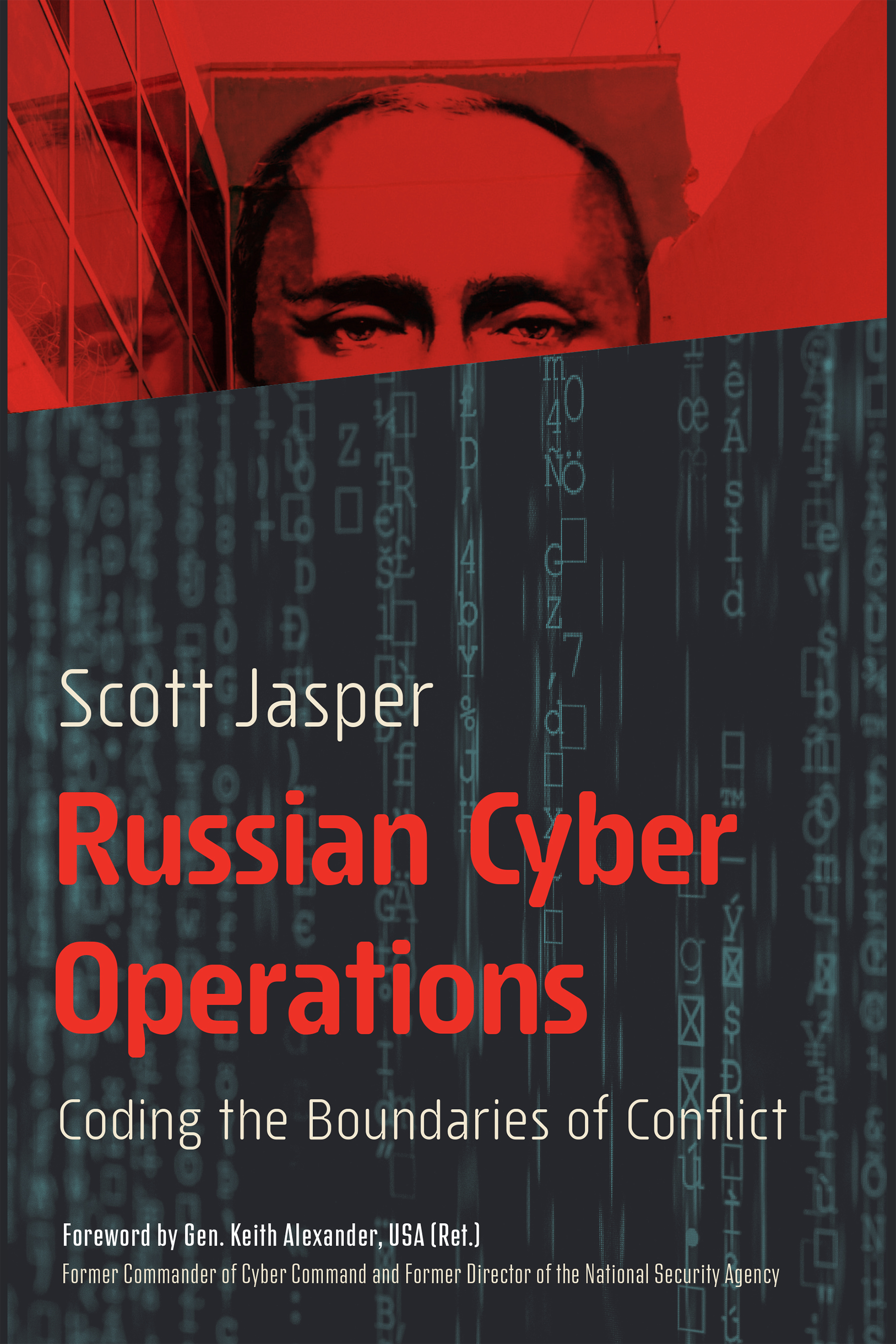
Russian Cyber Operations Russia has deployed cyber operations while maintaining a veneer of deniability and avoiding direct acts of war. In Russian Cyber Operations, Scott Jasper dives into the legal and technical maneuvers of Russian cyber strategies, proposing nations develop solutions for resilience to withstand attacks. POLITICAL SCIENCE,Security (National & International)
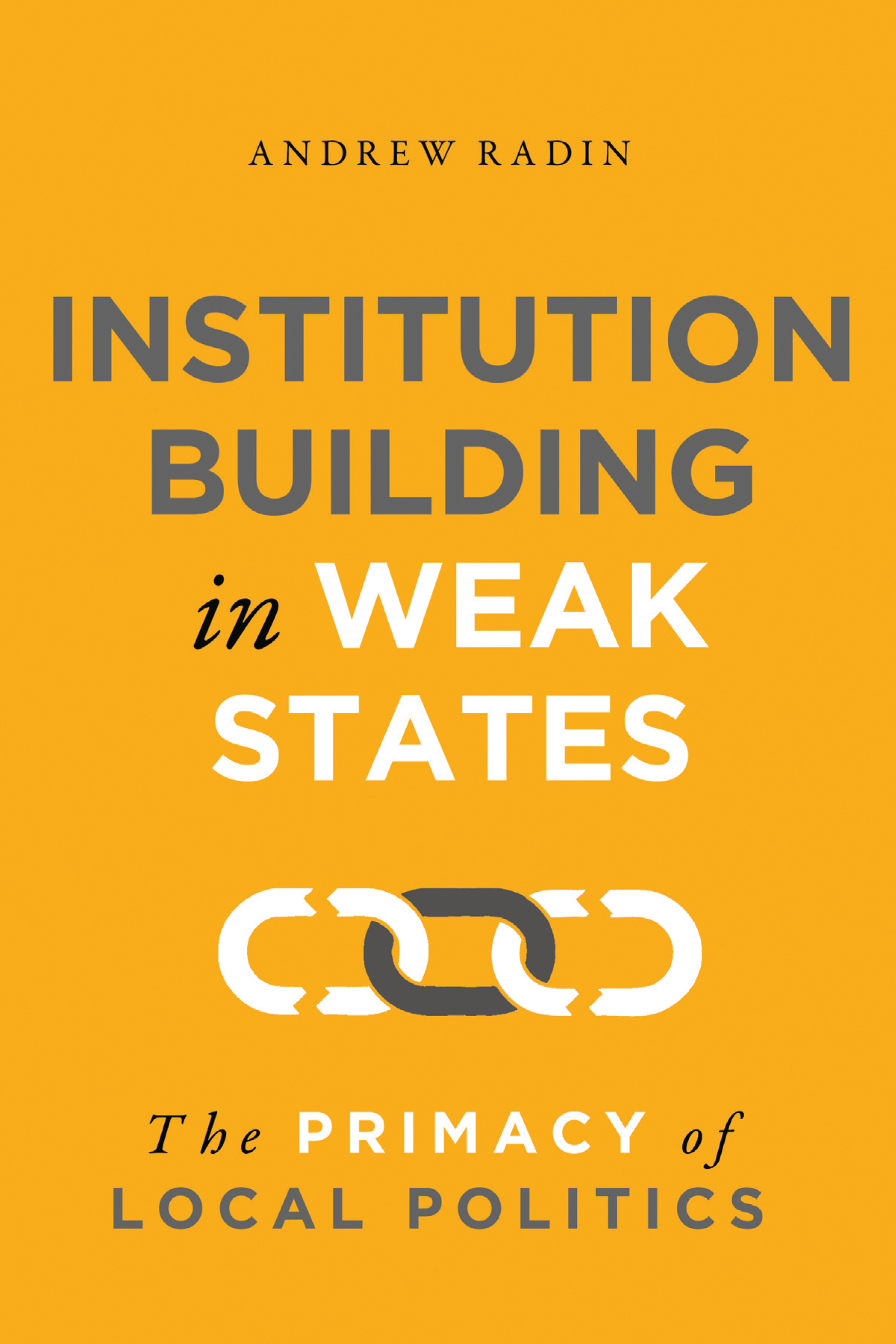
Institution Building in Weak States Andrew Radin’s Institution Building in Weak States introduces a domestic opposition theory that helps explain why institution building fails and what is required to make it work, offering a corrective for scholars of post-conflict missions, international development, and peacebuilding. POLITICAL SCIENCE,Security (National & International)
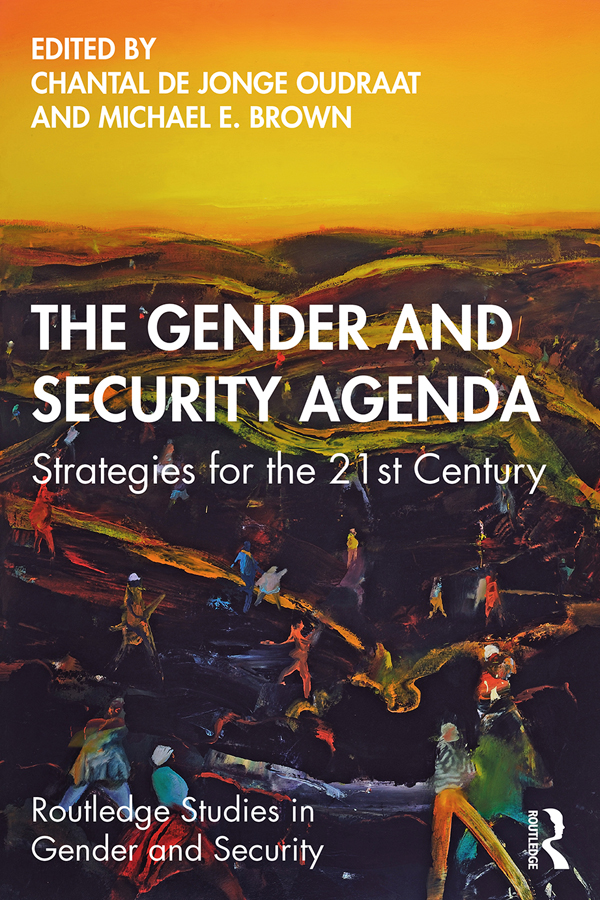
The Gender and Security Agenda This book examines the gender dimensions of a wide array of national and international security challenges. The volume examines gender dynamics in ten issue areas in both the traditional and human security sub-fields: armed conflict, post-conflict, terrorism, military organizations, movement of people, development, environment, humanitarian emergencies, human rights, governance. The contributions show how gender affects security and how security problems affect gender issues. Each chapter also examines a common set of key factors across the issue areas: obstacles to progress, drivers of progress and long-term strategies for progress in the 21st century. The volume develops key scholarship on the gender dimensions of security challenges and thereby provides a foundation for improved strategies and policy directions going forward. The lesson to be drawn from this study is clear: if scholars, policymakers and citizens care about these issues, then they need to think about both security and gender. This will be of much interest to students of gender studies, security studies, human security and International Relations in general. POLITICAL SCIENCE,Security (National & International)

Targeted Killings, Law and Counter-Terrorism Effectiveness This book examines the permissibility and effectiveness of targeted killing in campaigns against terror. Targeted killing has become a primary counterterrorism measure used by several countries in their confrontation with lethal threats. The practice has been extensively used by the US in Afghanistan, Iraq, Pakistan, Yemen and Somalia, and by Israel in the West Bank and Gaza. Several studies have already explored the difficult balance between achieving security while maintaining the liberties and rights of a country’s civilians. This book goes a step further by seeking to examine whether maintaining those liberties by complying with legal standards and minimizing unintended deaths can be more effective for national security. Using targeted killing applied by Israel, in particular, as well as the United States during the first decade of the twenty-first century as case studies, this book explores that question and ultimately assesses whether compliance with legal standards can strengthen a state in its campaign against terrorism and thus provide stronger security. The book focuses on civilian-related criteria, hypothesizing that minimizing civilian casualties will maximize effectiveness in an asymmetric war setting. The conclusions are not limited to a specific tactic or theater, and if adopted might have far-reaching implications for how asymmetric warfare is strategized. This book will be of much interest to students of counter-terrorism, law, Middle Eastern studies, and security studies. POLITICAL SCIENCE,Security (National & International)
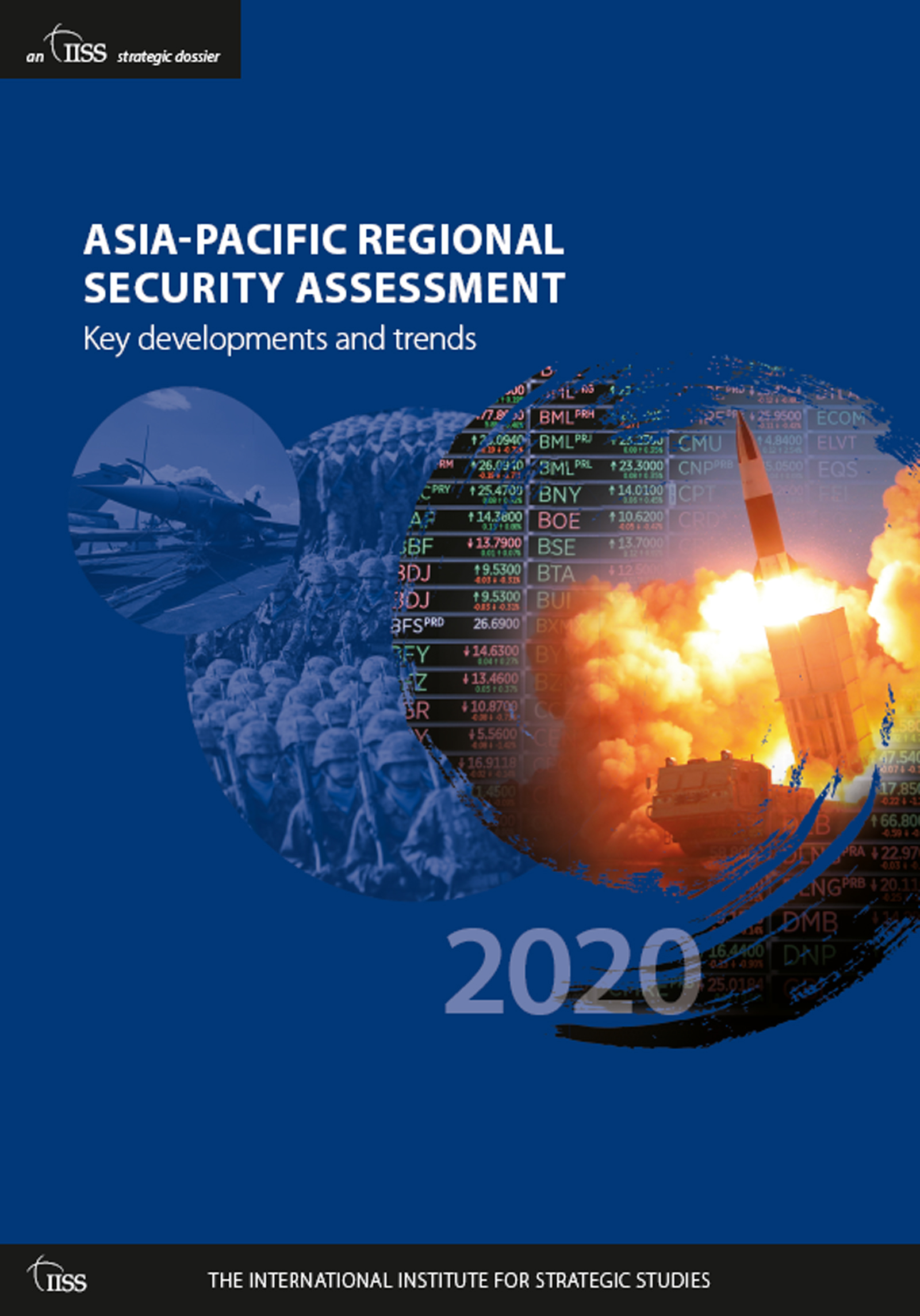
Asia-Pacific Regional Security Assessment 2020 The Asia-Pacific Regional Security Assessment provides insight into key regional strategic, geopolitical, economic, military and security topics. Among the topics explored are: the deteriorating USï€China relationship and great-power competition; US alliances and security partnerships; the collapse of the Intermediate-range Nuclear Forces Treaty; diplomatic gridlock on the Korean Peninsula; Japan’s role in Indo-Pacific security; the breakdown in Japan–South Korea relations; Indonesian policy towards the South China Sea; Australia’s defence and security outlook; the European security role in Asia. Authors include leading regional analysts and academics Douglas Barrie, William Choong, Aaron Connelly, Andrew Davies, Michael Elleman, Bonnie S. Glaser, Euan Graham, Christopher W. Hughes, Meia Nouwens, Brendan Taylor and William Tow. POLITICAL SCIENCE,Security (National & International)
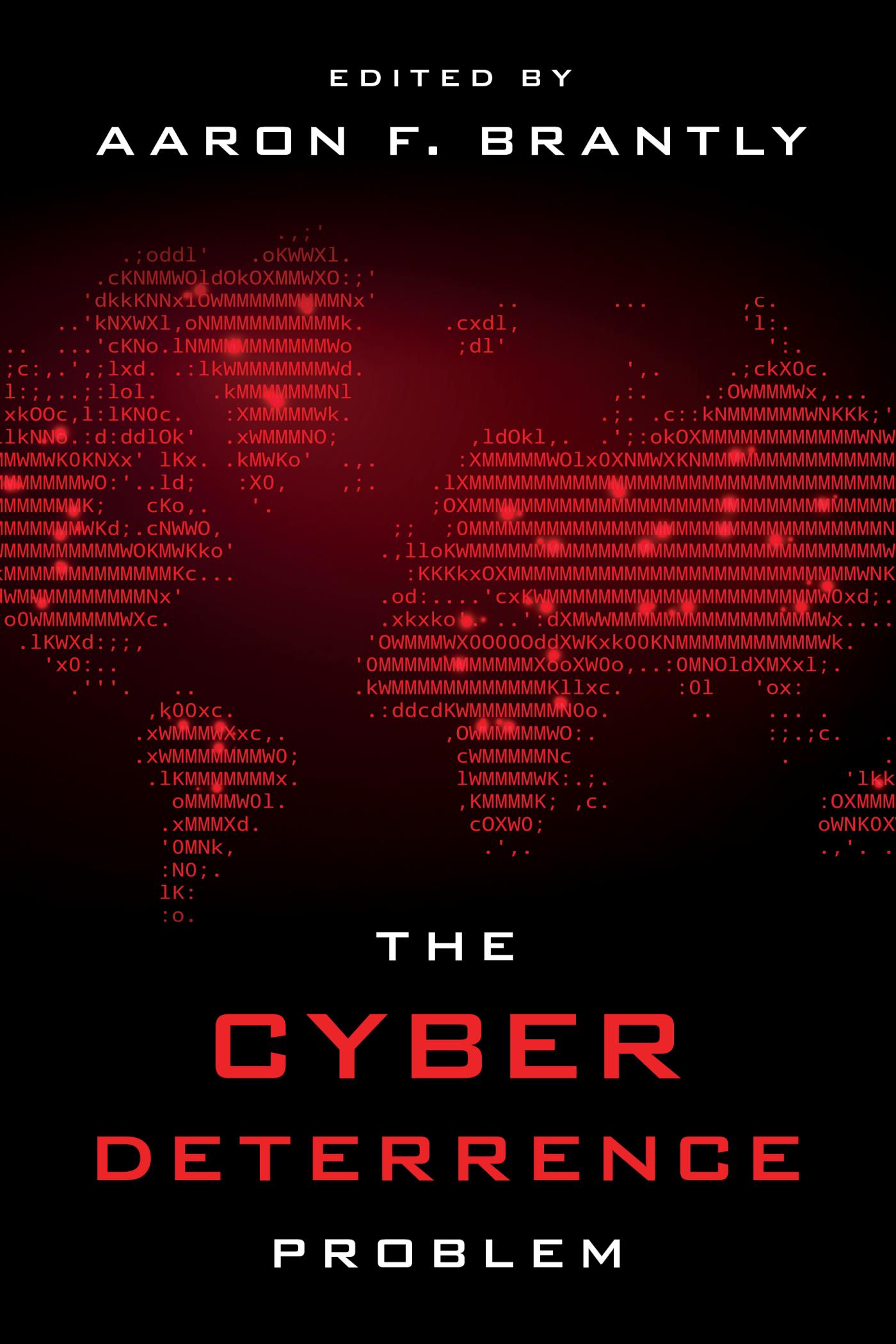
The Cyber Deterrence Problem The Cyber Deterrence Problem brings together a multi-disciplinary team of scholars from multiple institutions to analyze and develop a robust assessment of the necessary requirements and attributes for achieving deterrence in cyberspace. POLITICAL SCIENCE,Security (National & International)
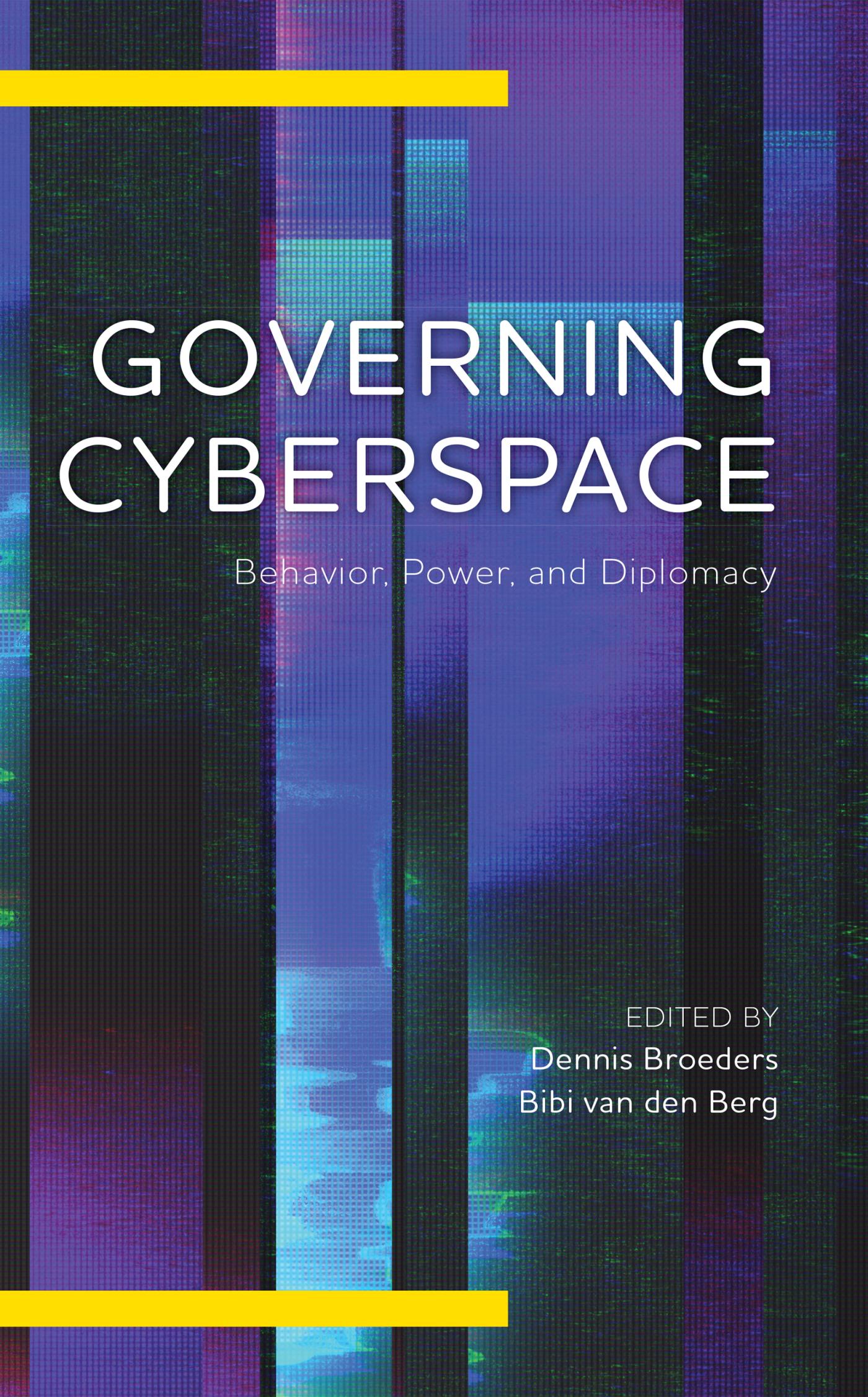
Governing Cyberspace Contributes to the discussion of growing insecurity and the unpredictable and often authoritarian use of the digital ecosystem. POLITICAL SCIENCE,Security (National & International)

The Use of Force for State Power This book studies force, the coercive application of power against resistance, building from Thomas Hobbes’ observation that all self-contained political orders have some ultimate authority that uses force to both dispense justice and to defend the polity against its enemies. This cross-disciplinary analysis finds that rulers concentrate force through cooperation, conveyance, and comprehension, applying common principles across history. Those ways aim to keep foes from concerting their actions, or by eliminating the trust that should bind them. In short, they make enemies afraid to cooperate, and now they are doing so in cyberspace as well. POLITICAL SCIENCE,Security (National & International)
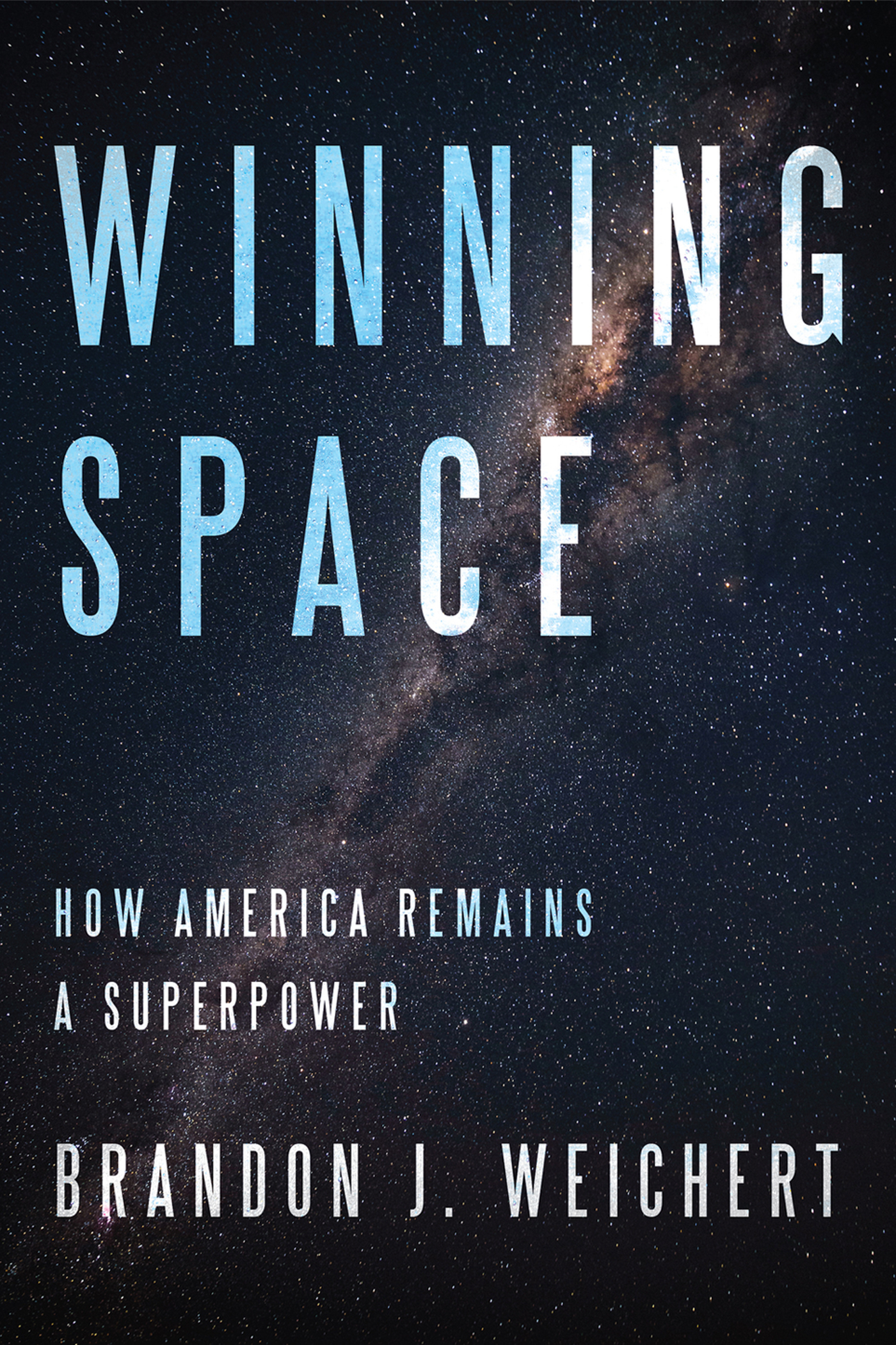
Winning Space When President Donald J. Trump announced the creation of America's sixth branch of the military, the United States Space Force, many in Washington scoffed. But, U.S. rivals in China, Russia, Iran, and North Korea took notice. Since the end of the Cold War, these American foes have chafed under the full-spectrum dominance that the American superpower has enjoyed globally. They have identified space as a key strategic domain where they can challenge—and possibly defeat—the United States military. And, depriving the U.S. military and/or its economy of access to space during an international crisis could spell doom for the United States in other strategic domains (land, sea, air, and cyberspace). After all, space is critical for America's vaunted information dominance. Satellites overhead are the backbone of America's global military. Remove them from orbit and U.S. forces worldwide are rendered deaf, dumb, and blind. What's more, space is a more than $1 trillion economy just waiting to be developed. Whichever country gets there first will have considerable economic and geopolitical power on Earth. Despite President Trump's creation of the Space Force, Swamp Dwellers in Washington continue resisting his reforms to U.S. space and technology policy.Winning Space tracks the increasing competition the United States is facing in the technology sector and depicts how the United States has been engaged in a Second Space Race—and how it has been losing. Author Brandon Weichert warns how the United States is at risk for a Pearl Harbor-type event in space. Weichert advocates for the full embrace of Trump's reforms for America's flailing space policy, while also calling for a minimum $1 trillion investment in advanced research and development here in the United States, to stay ahead of America's advancing foes. Contrary to what many Americans may think, the United States has been declining in space and the high-technology development sector. Should it lose its dominance in these areas, it will surely lose its superpower status. The next decade presents U.S. policymakers one last chance to preserve the superpower status that America fought two world wars and the Cold War to build. Time is not on our side. We are on notice, but we have not noticed. POLITICAL SCIENCE,Security (National & International)
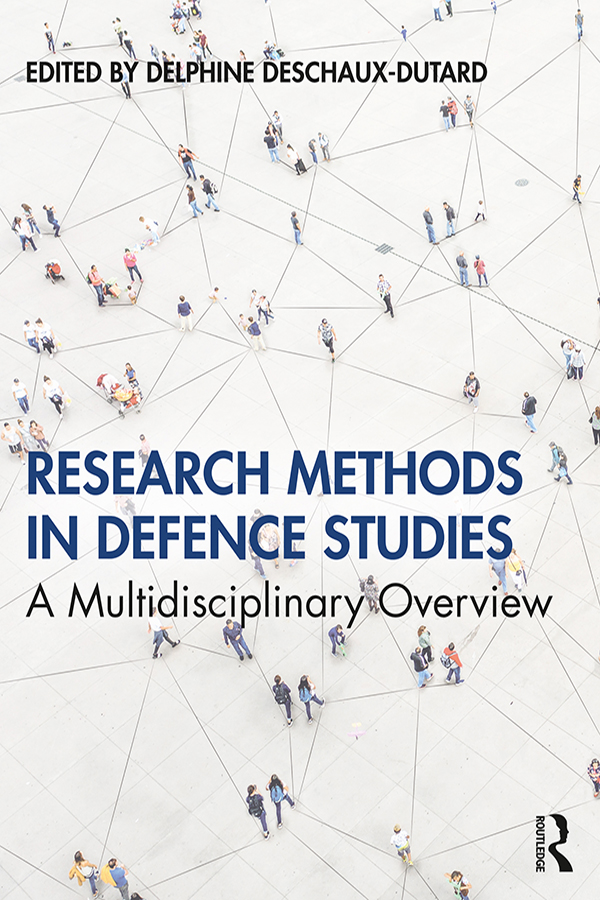
Research Methods in Defence Studies This textbook provides an overview of qualitive and quantitative methods used in different social sciences to investigate defence issues. Recently, defence issues have become of increasing interest to researchers in the social sciences, but they raise specific methodological questions. This volume intends to fill a gap in the literature on defence studies by addressing a number of topics not dealt with sufficiently before. The contributors offer a range of methodological reflections and tools from various social sciences (political science, sociology, geography, history, economics and public law) for researching defence issues. They also address the increasingly important question of data and digitalization. The book introduces the added value of quantitative and qualitative methods, and calls for a cross-fertilization of methods in order to facilitate better research on defence topics and to fully grasp the complexity of defence in the 21st century. This book will be of much interest to students, researchers and practitioners of defence studies, war studies, military studies, and social science research methods in general. POLITICAL SCIENCE,Security (National & International)

Security and Stability in the New Space Age This book examines the drivers behind great power security competition in space to determine whether realistic strategic alternatives exist to further militarization. Space is an area of increasing economic and military competition. This book offers an analysis of actions and events indicative of a growing security dilemma in space, which is generating an intensifying arms race between the US, China, and Russia. It explores the dynamics behind a potential future war in space and investigates methods of preventing an arms race from an international relations theory and military-strategy standpoint. The book is divided into three parts: the first section offers a broad discussion of the applicability of international relations theory to current conditions in space; the second is a direct application of theory to the space environment to determine whether competition or cooperation is the optimal strategic choice; the third section focuses on testing the hypotheses against reality, by analyzing novel alternatives to three major categories of space systems. The volume concludes with a study of the practical limitations of applying a strategy centered on commercialization as a method of defusing the orbital security dilemma. This book will be of interest to students of space power, strategic studies, and international relations. POLITICAL SCIENCE,Security (National & International)
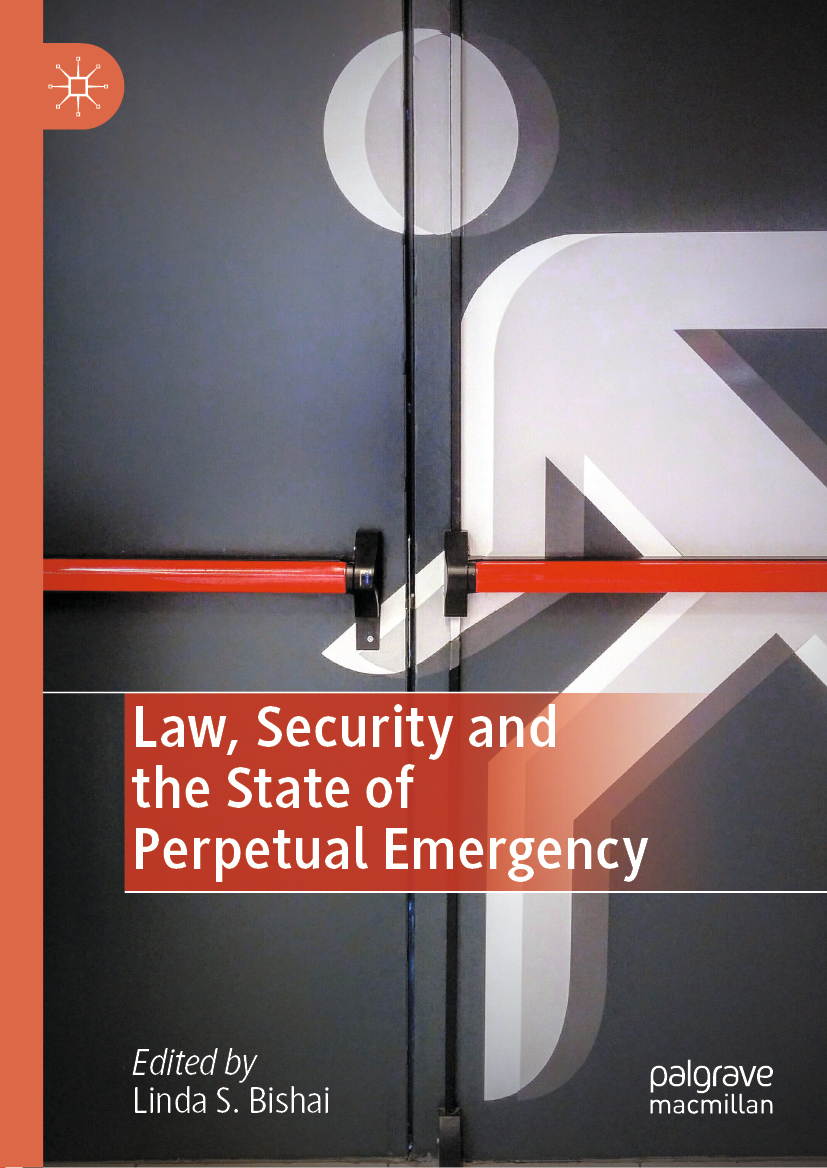
Law, Security and the State of Perpetual Emergency Presenting diverse contributors from legal, academic, and practitioner sectors, this book illustrates how the distinctions between international and domestic law are falling away in the context of security, particularly in the responses to terrorism, and explores the implications of these dramatic shifts in the normative order. Fundamental changes in the powers of the state and the rights of populations have accelerated since the globalized response to 9/11, creating effects that spread beyond borders and operate in a new, as yet under-conceptualized space. Although these altered practices were said to be in response to exceptional circumstances — a response to terrorism — they have become increasingly established in an altered baseline norm. This book explores the (inter)national implications of exceptional legal efforts to protect states’ domestic space in the realm of security. POLITICAL SCIENCE,Security (National & International)
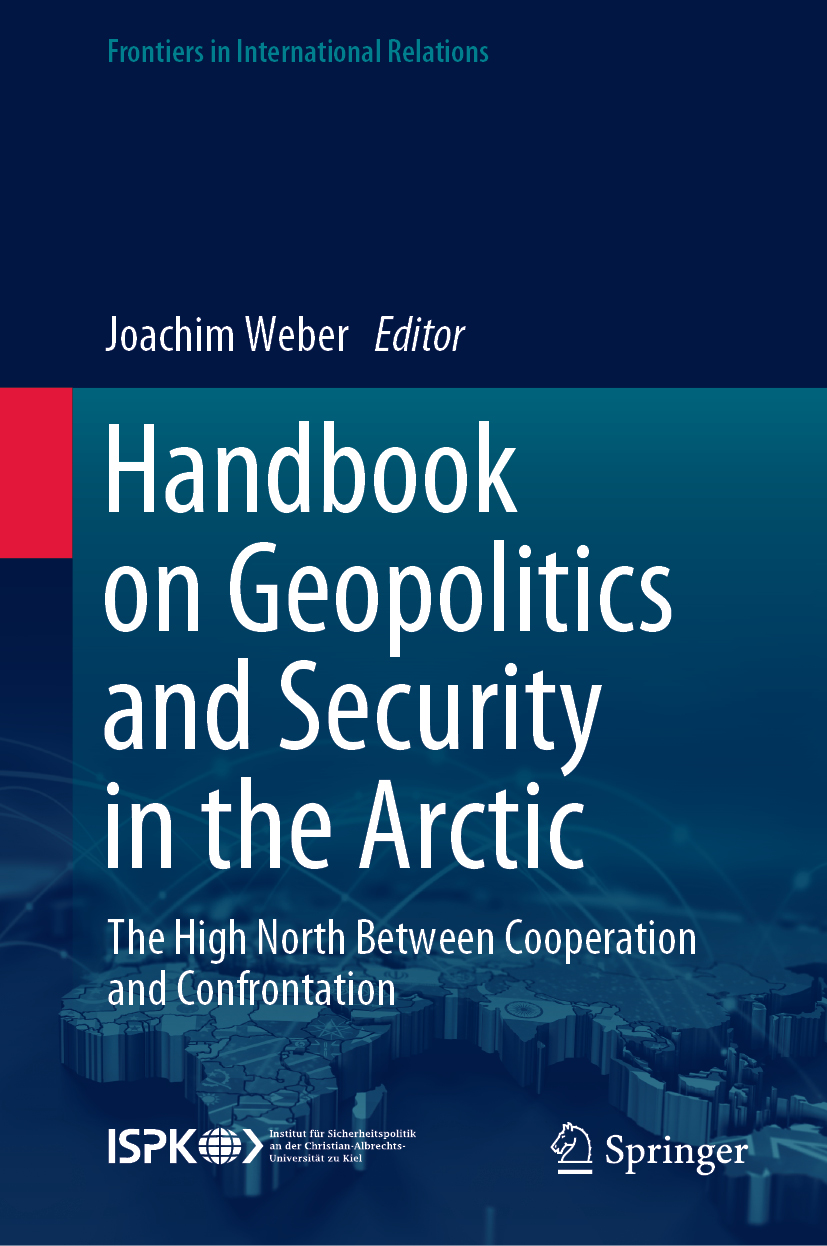
Handbook on Geopolitics and Security in the Arctic Against the backdrop of climate change and tectonic political shifts in world politics, this handbook provides an overview of the most crucial geopolitical and security related issues in the Arctic. It discusses established shareholder's policies in the Arctic – those of Russia, Canada, the USA, Denmark, and Norway – as well as the politics and interests of other significant or future stakeholders, including China and India. Furthermore, it explains the economic situation and the legal framework that governs the Arctic, and the claims that Arctic states have made in order to expand their territories and exclusive economic zones. While illustrating the collaborative approach, represented by institutions such as the Arctic council, which has often been described as an exceptional institution in this region, the contributing authors examine potential resource and power conflicts between Arctic nations, due to competing interests. The authors also address topics such as changing alliances between Arctic nations, new sea lines of communication, technological shifts, and eventually the return to power politics in the area. Written by experts on international security studies and the Arctic, as well as practitioners from government institutions and international organizations, the book provides an invaluable source of information for anyone interested in geopolitical shifts and security issues in the High North. POLITICAL SCIENCE,Security (National & International)

Innovation, Dual Use, and Security A framework for assessing the security risks of emerging dual-use technologies and devising tailored governance strategies is proposed and applied to contemporary case studies. Recent advances in disciplines such as biotechnology, nanotechnology, and neuropharmacology entail a “dual-use dilemma” because they promise benefits for human health and welfare yet pose the risk of misuse for hostile purposes. The emerging field of synthetic genomics, for example, can produce custom DNA molecules for life-saving drugs but also makes possible the creation of deadly viral agents for biological warfare or terrorism. The challenge for policymakers is to prevent the misuse of these new technologies without forgoing their benefits. Innovation, Dual Use, and Security offers a systematic approach for managing the dual-use dilemma. The book presents a “decision framework” for assessing the security risks of emerging technologies and fashioning governance strategies to manage those risks. This framework is applied to fourteen contemporary case studies, including synthetic genomics, DNA shuffling and directed evolution, combinatorial chemistry, protein engineering, immunological modulation, and aerosol vaccines. The book also draws useful lessons from two historical cases: the development of the V-series nerve agents in Britain and the use and misuse of LSD by the U.S. Army and the CIA. Innovation, Dual Use, and Security offers a comprehensive, multifaceted introduction to the challenges of governing dual-use technologies in an era of rapid innovation. The book will be of interest to government officials and other practitioners as well as to students and scholars in security studies, science and technology studies, biology, and chemistry. POLITICAL SCIENCE,Security (National & International)
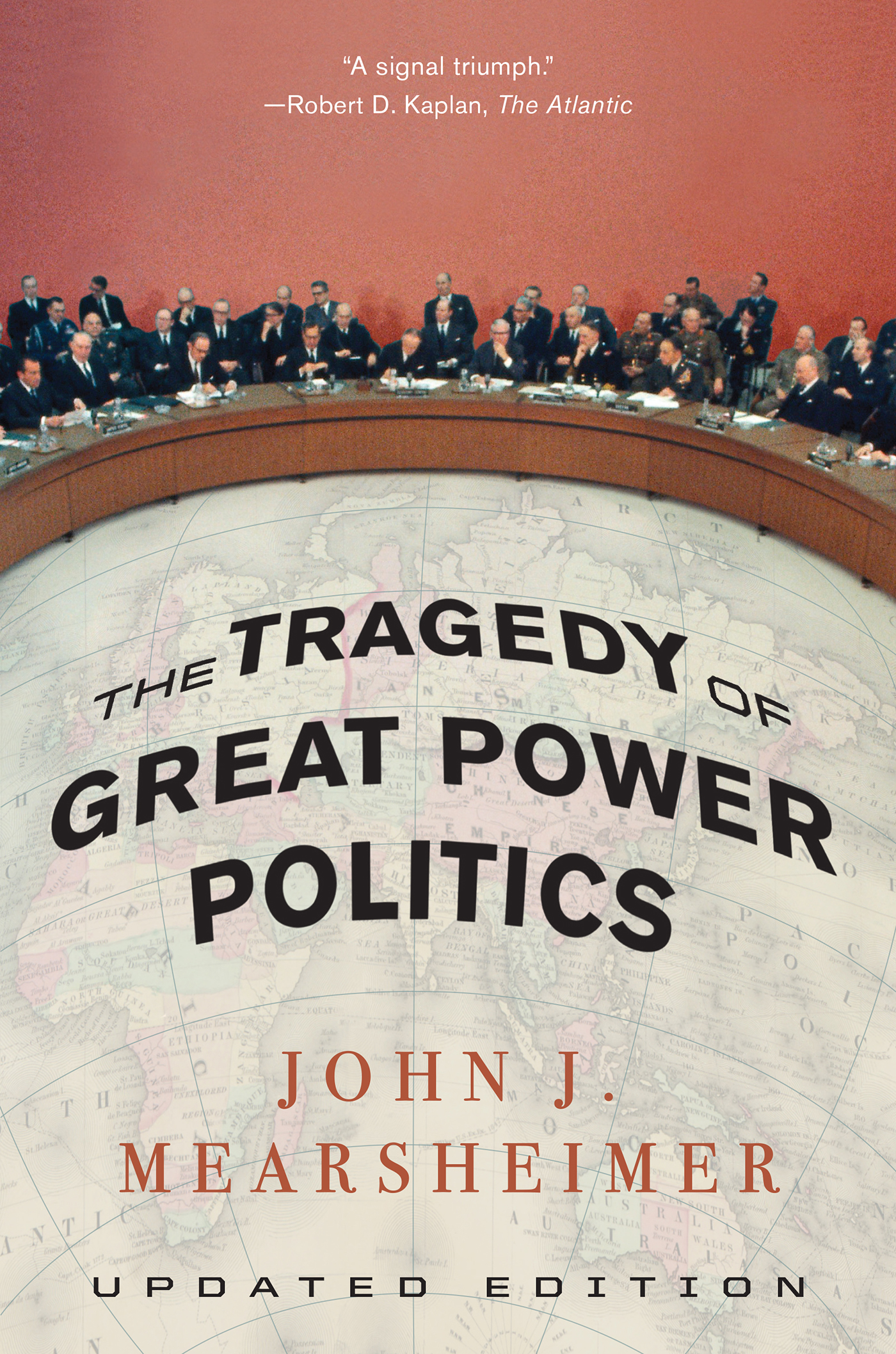
The Tragedy of Great Power Politics (Updated Edition) "A superb book.…Mearsheimer has made a significant contribution to our understanding of the behavior of great powers."—Barry R. Posen, The National Interest The updated edition of this classic treatise on the behavior of great powers takes a penetrating look at the question likely to dominate international relations in the twenty-first century: Can China rise peacefully? In clear, eloquent prose, John Mearsheimer explains why the answer is no: a rising China will seek to dominate Asia, while the United States, determined to remain the world's sole regional hegemon, will go to great lengths to prevent that from happening. The tragedy of great power politics is inescapable. POLITICAL SCIENCE,Security (National & International)

Weaponized Marketing Because Islamic jihad wins through marketing, Weaponized Marketing proposes to fight back with this marketing battle plan that uses the techniques that built the world’s leading brands to succeed where military might and diplomacy have failed. POLITICAL SCIENCE,Security (National & International)

Narrativized Strategic Choice Offers useful theory building process tracing the narrative turn to strategic choice both methodological and theoretical innovations. POLITICAL SCIENCE,Security (National & International)

Cyber Security Education This book investigates the goals and policy aspects of cyber security education in the light of escalating technical, social and geopolitical challenges. The past ten years have seen a tectonic shift in the significance of cyber security education. Once the preserve of small groups of dedicated educators and industry professionals, the subject is now on the frontlines of geopolitical confrontation and business strategy. Global shortages of talent have created pressures on corporate and national policy for workforce development. Cyber Security Education offers an updated approach to the subject as we enter the next decade of technological disruption and political threats. The contributors include scholars and education practitioners from leading research and education centres in Europe, North America and Australia. This book provides essential reference points for education policy on the new social terrain of security in cyberspace and aims to reposition global debates on what education for security in cyberspace can and should mean. This book will be of interest to students of cyber security, cyber education, international security and public policy generally, as well as practitioners and policy-makers. POLITICAL SCIENCE,Security (National & International)
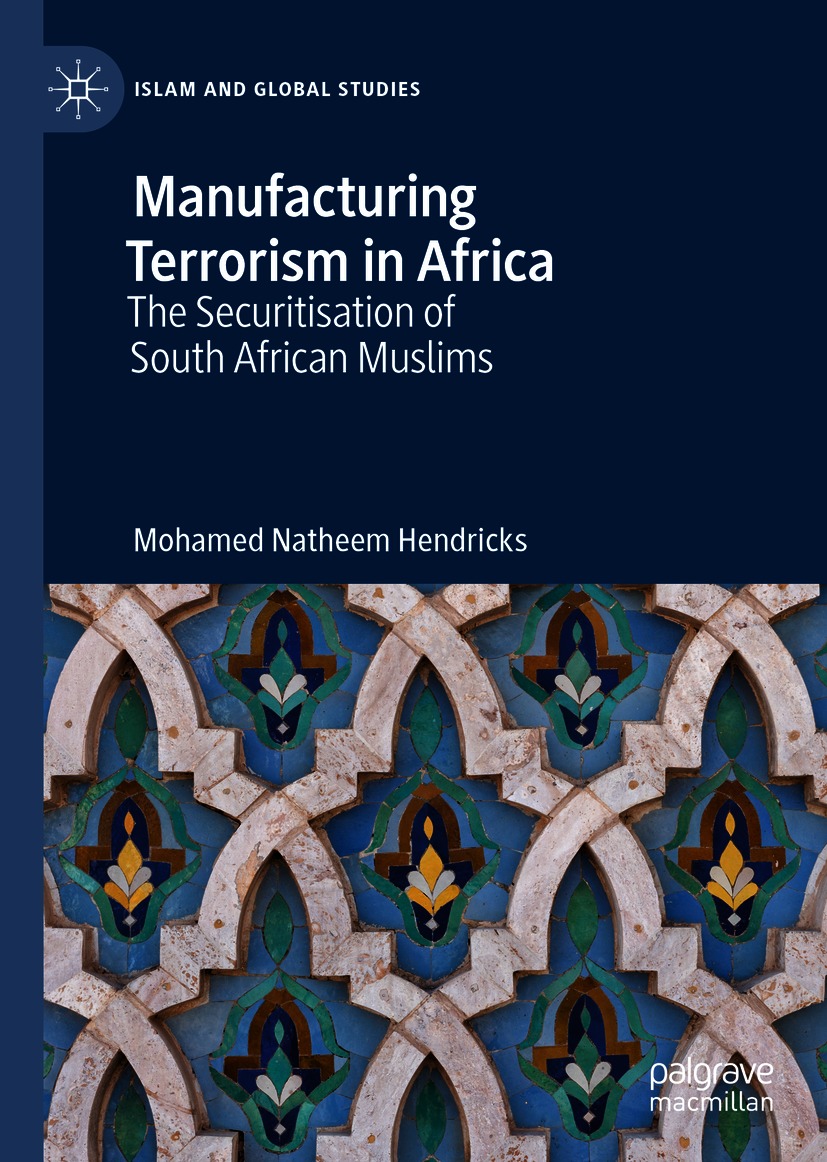
Manufacturing Terrorism in Africa This book uses Securitisation Theory to explore how Muslims have been constructed as a security issue in Africa after the 9/11 attacks in the United States. These attacks became the rationale for the US’s Global War on Terror (GWOT). The centrality of Africa as an arena to execute the GWOT is the focus of this book. This book explores, particularly, how western-centred security discourses around Muslims has permeated South African security discourse in the post-apartheid period. It claims that the popular press and the local think-tank community were critical knowledge-sites that imported rather than interrogated debates which have underpinned policy-initiatives such as the GWOT. Such theorisation seems contrary to the original architects of securitisation theory who maintain that issues become security concerns when institutional voices declare these as such. However, this book confirms that non-institutional voices have securitised the African Muslims by equating them with terrorism. This book illustrates that such securitisation reproduces partisan knowledge that promote Western interests. POLITICAL SCIENCE,Security (National & International)
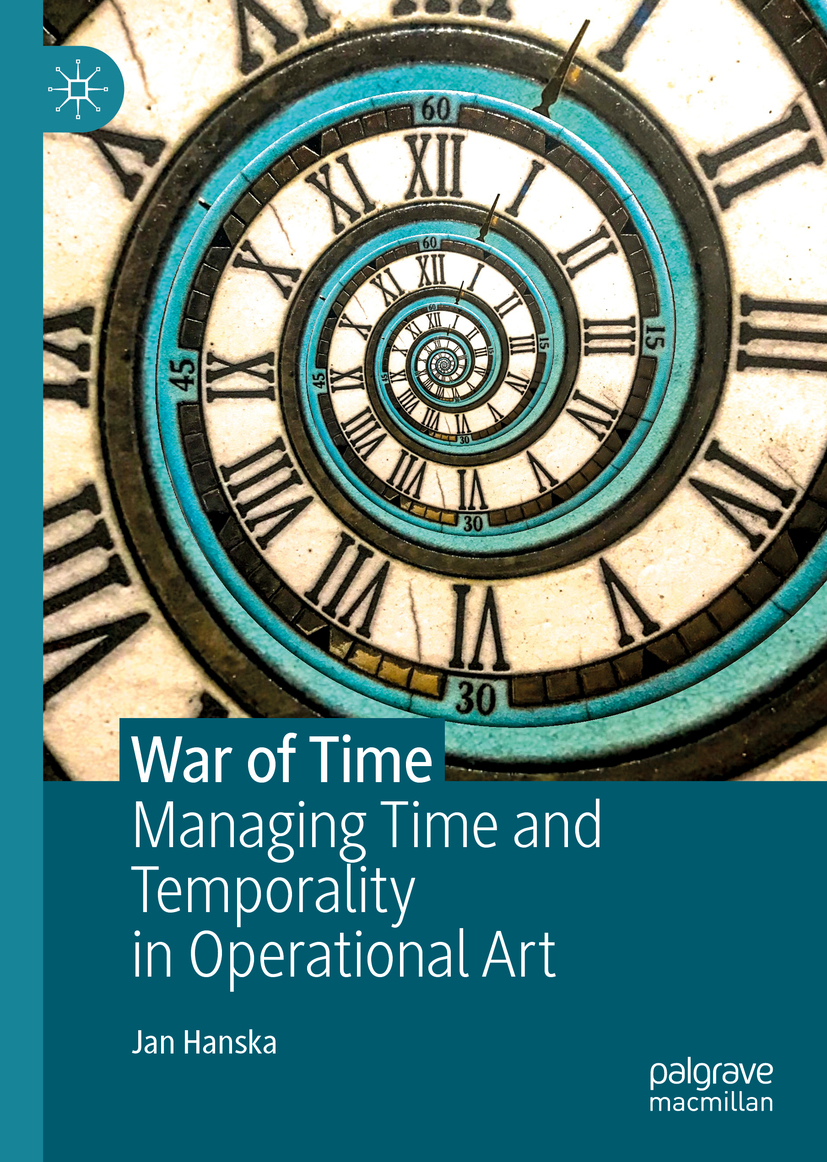
War of Time This book examines the meaning and management of time as a facet of the art of war in general but especially operational art. While force-time-place has for a long time been considered to be the essential trinity of warfare, the aspect of time remains largely under-researched. Relying on classic texts on art of war, the author engages with some of the top theorists and practitioners of art of war from the age of Sun Tzu to the network-centric warfare about the role of time and its management in operational art. Relying on Alvin Toffler’s theory of the “three waves,†the volume follows research into development of operational art through cycles from the agrarian age to the industrial age and into the information age. POLITICAL SCIENCE,Security (National & International)
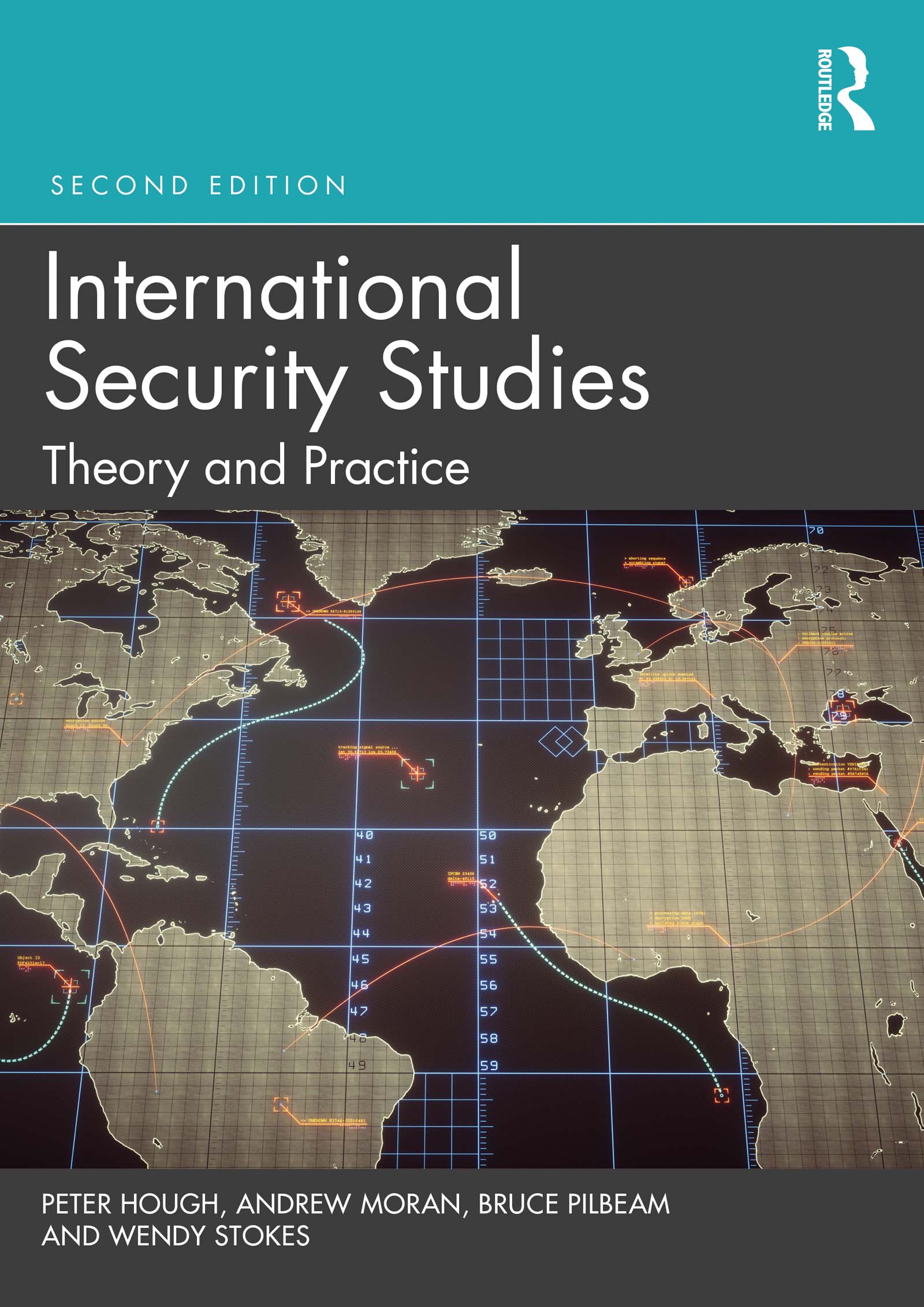
International Security Studies This new and updated edition of International Security Studies provides students with a comprehensive introduction to the subject of security studies, with a strong emphasis on the use of case studies to illustrate theoretical debates. In addition to presenting the major theoretical perspectives, the book examines a range of important and controversial topics in covering both traditional military and non-military security issues such as WMD proliferation, humanitarian intervention, food security and environmental security. The volume also offers a wide range of case studies providing detailed analyses of important global security issues. The 37 chapters contain pedagogical features and recommended further reading and are divided into five thematic sections: Conceptual and Theoretical Military Security Non-Military Security Institutions and Security Case Studies Updates for the second edition include: New chapters on cybersecurity and the insecurity of the LGBT community. Substantial revisions to existing chapters to incorporate analysis of important international political developments, including the Trump Presidency; ‘Brexit’; North Korean nuclear standoff; the Syrian Civil War; Yemen Civil War; Mediterranean migration crisis; Climate change diplomacy and the Sustainable Development Goals. This textbook will be essential reading for all students of security studies and highly recommended for students of critical security studies, human security, peace and conflict studies, foreign policy and International Relations in general. POLITICAL SCIENCE,Security (National & International)

Moscow's War in Syria The CSIS Transnational Threats Project assesses Russia's military and diplomatic campaign in Syria, the largest and most significant Russian out-of-area operation since the end of the Cold War. POLITICAL SCIENCE,Security (National & International)

Under Beijing's Shadow This compelling book provides a snapshot of how ten countries of Southeast Asia view China with a nuanced mix of hope and anxiety. The stunning growth of China has yanked up the region’s economies, but its militarization of the South China Sea and dam building on the Mekong River has nations uneasy about their neighbor’s outsized ambitions. POLITICAL SCIENCE,Security (National & International)
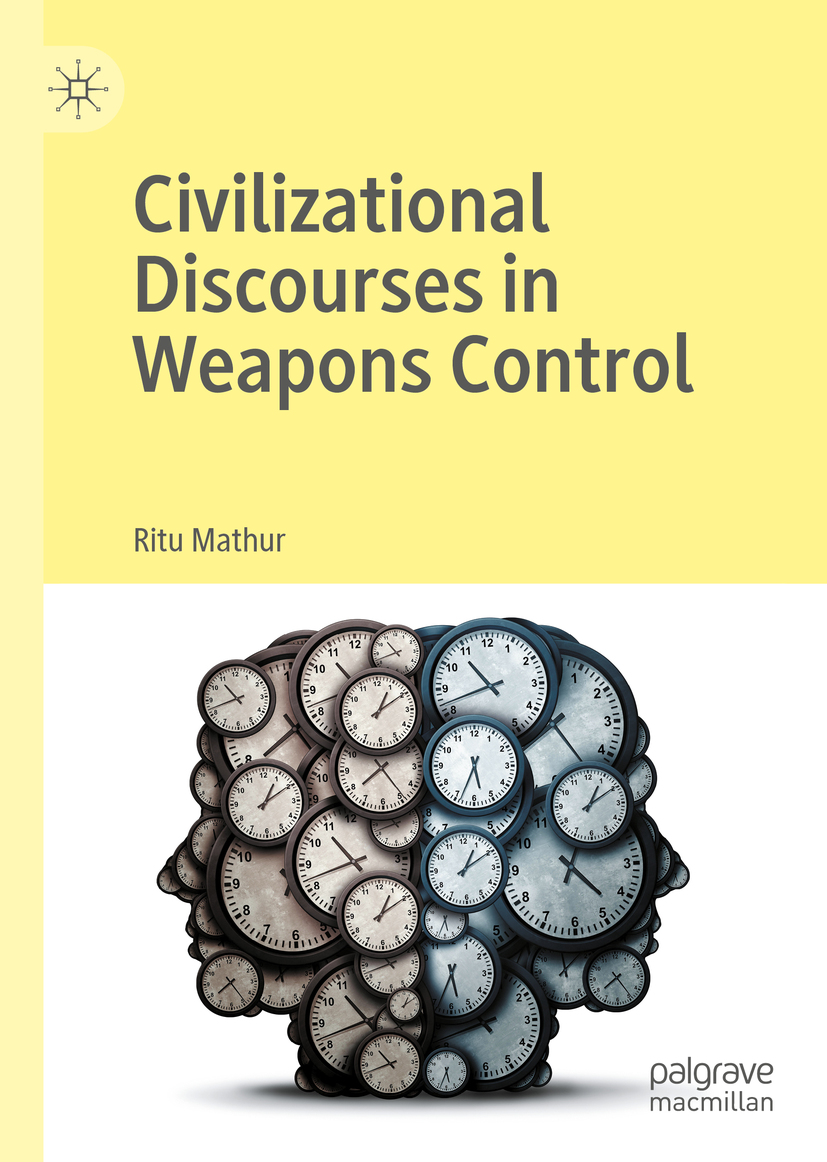
Civilizational Discourses in Weapons Control This book seeks to decolonize practices of arms control and disarmament. In this endeavor it seeks to problematize our understanding of time and civilization as rhetorical resources. The need for such an undertaking can be premised on the claim that while problems of modernity, ethnocentrism and universalism are now a central concern within the field of international relations, these ideas are scarcely debated or contested within the field of arms control and disarmament. The singular focus on technological innovations and specific policy-oriented agreements in practices of arms control and disarmament appears to stymie the need for such engagements. This book is an invitation to explore intersecting discourses on colonialism, racialism, nationalism and humanitarianism within a historically grounded terrain of weapons control. An understanding of these practices is vital not to prescribe any standards of civilization or exceptionalism in weapons control but to be cognizant through critique of the dangers embedded in any effort at reconstellating the constitutional nuclear order. POLITICAL SCIENCE,Security (National & International)
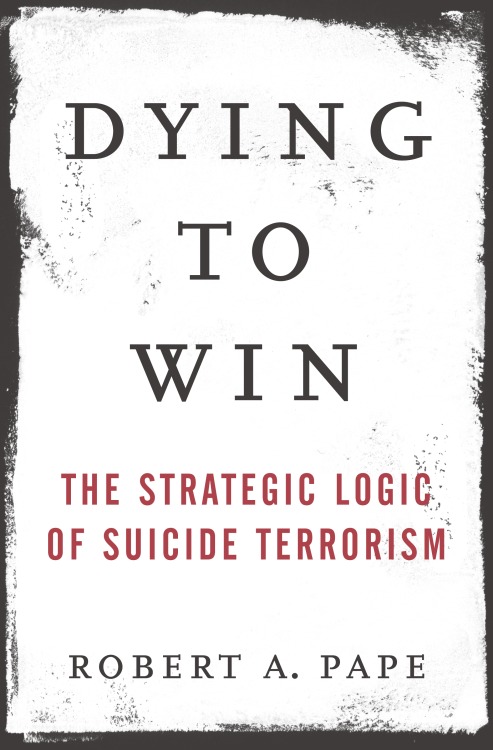
Dying to Win Suicide terrorism is rising around the world, but there is great confusion as to why. In this paradigm-shifting analysis, University of Chicago political scientist Robert Pape has collected groundbreaking evidence to explain the strategic, social, and individual factors responsible for this growing threat. One of the world’s foremost authorities on the subject, Professor Pape has created the first comprehensive database of every suicide terrorist attack in the world from 1980 until today. With striking clarity and precision, Professor Pape uses this unprecedented research to debunk widely held misconceptions about the nature of suicide terrorism and provide a new lens that makes sense of the threat we face. FACT: Suicide terrorism is not primarily a product of Islamic fundamentalism. FACT: The world’s leading practitioners of suicide terrorism are the Tamil Tigers in Sri Lanka–a secular, Marxist-Leninist group drawn from Hindu families. FACT: Ninety-five percent of suicide terrorist attacks occur as part of coherent campaigns organized by large militant organizations with significant public support. FACT: Every suicide terrorist campaign has had a clear goal that is secular and political: to compel a modern democracy to withdraw military forces from the territory that the terrorists view as their homeland. FACT: Al-Qaeda fits the above pattern. Although Saudi Arabia is not under American military occupation per se, one major objective of al-Qaeda is the expulsion of U.S. troops from the Persian Gulf region, and as a result there have been repeated attacks by terrorists loyal to Osama bin Laden against American troops in Saudi Arabia and the region as a whole. FACT: Despite their rhetoric, democracies–including the United States–have routinely made concessions to suicide terrorists. Suicide terrorism is on the rise because terrorists have learned that it’s effective. In this wide-ranging analysis, Professor Pape offers the essential tools to forecast when some groups are likely to resort to suicide terrorism and when they are not. He also provides the first comprehensive demographic profile of modern suicide terrorist attackers. With data from more than 460 such attackers–including the names of 333–we now know that these individuals are not mainly poor, desperate criminals or uneducated religious fanatics but are often well-educated, middle-class political activists. More than simply advancing new theory and facts, these pages also answer key questions about the war on terror: • Are we safer now than we were before September 11?• Was the invasion of Iraq a good counterterrorist move? • Is al-Qaeda stronger now than it was before September 11? Professor Pape answers these questions with analysis grounded in fact, not politics, and recommends concrete ways for today’s states to fight and prevent terrorist attacks. Military options may disrupt terrorist operations in the short term, but a lasting solution to suicide terrorism will require a comprehensive, long-term approach–one that abandons visions of empire and relies on a combined strategy of vigorous homeland security, nation building in troubled states, and greater energy independence. For both policy makers and the general public, Dying to Win transcends speculation with systematic scholarship, making it one of the most important political studies of recent time. POLITICAL SCIENCE,Terrorism

Inside 9-11 Some of the finest writing and reporting on the events of September 11 was done by Der Spiegel, Germany's magazine of record. With its main office in Hamburg, base of operations for terrorist ringleader Mohamed Atta and many of the others, Der Spiegel's journalists were on the front lines of the earliest investigation into the identities of those who brought holy war to America. The award-winning team from Spiegel was also at Ground Zero, talking to people, gathering stories, interviewing survivors, seeking the words that might express the interconnections of horror and heroism. The words come from those who had been inside and somehow gotten out. Inside 9-11 gives us some of their accounts, taking us as close as we can get to what happened. The "why" of September 11 may remain beyond understanding. But here we learn who the terrorists were, and how they were able to take so many innocent lives by sacrificing their own. The profiles in this book render a chilling, alien mindset that has become part of our daily reality. Combining first-class investigative journalism and writing of great clarity, Inside 9-11 is a heartbreaking and gripping reconstruction of the events that changed us all. Translated from the German by Paul De Angelis and Elisabeth Kaestner, with contributions from Margot Dembo and Christopher Sultan. POLITICAL SCIENCE,Terrorism
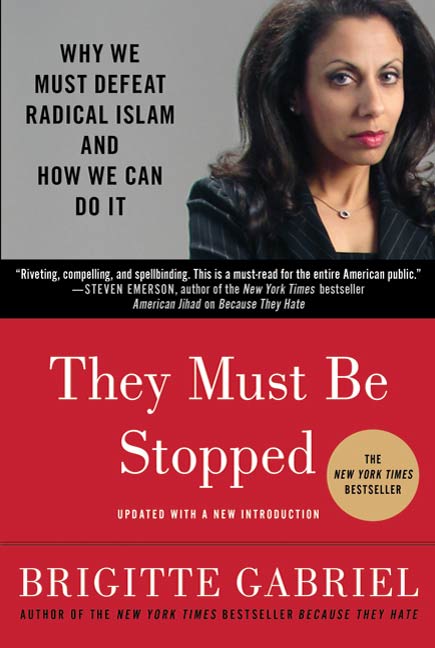
They Must Be Stopped They Must Be Stopped is New York Times bestselling author Brigitte Gabriel's warning to the world: We can no longer ignore the growth of radical Islam--we must act soon, and powerfully. Gabriel challenges our western and politically-correct notions about Islam, demonstrating why radical Islam is so deadly and how we can halt its progress. Brigitte Gabriel speaks her mind: *Fundamentalist Islam is a religion rooted in 7th century teachings that are fundamentally opposed to democracy and equality. *Radical Islamists are utterly contemptuous of all "infidels" (non-Muslims) and regard them as enemies worthy of death. *Madrassas in America are increasing in number, and they are just one part of a growing radical Islamic army on US soil. *Radical Islam exploits the US legal system and America's protection of religion to spread its hatred for western values. *America must organize a unified voice that says "enough" to political correctness, and demands that government officials and elected representatives do whatever is necessary to protect us. Brigitte Gabriel has fearlessly faced down critics, death threats, and political correctness, and is one of the most sought after terrorism experts in the world. They Must Be Stopped is her clarion call to action. Gabriel thoroughly addresses the historical and religious basis of radical Islam, its frightening encroachment into societies around the world, and its abuses of democracy in the name of religion. POLITICAL SCIENCE,Terrorism
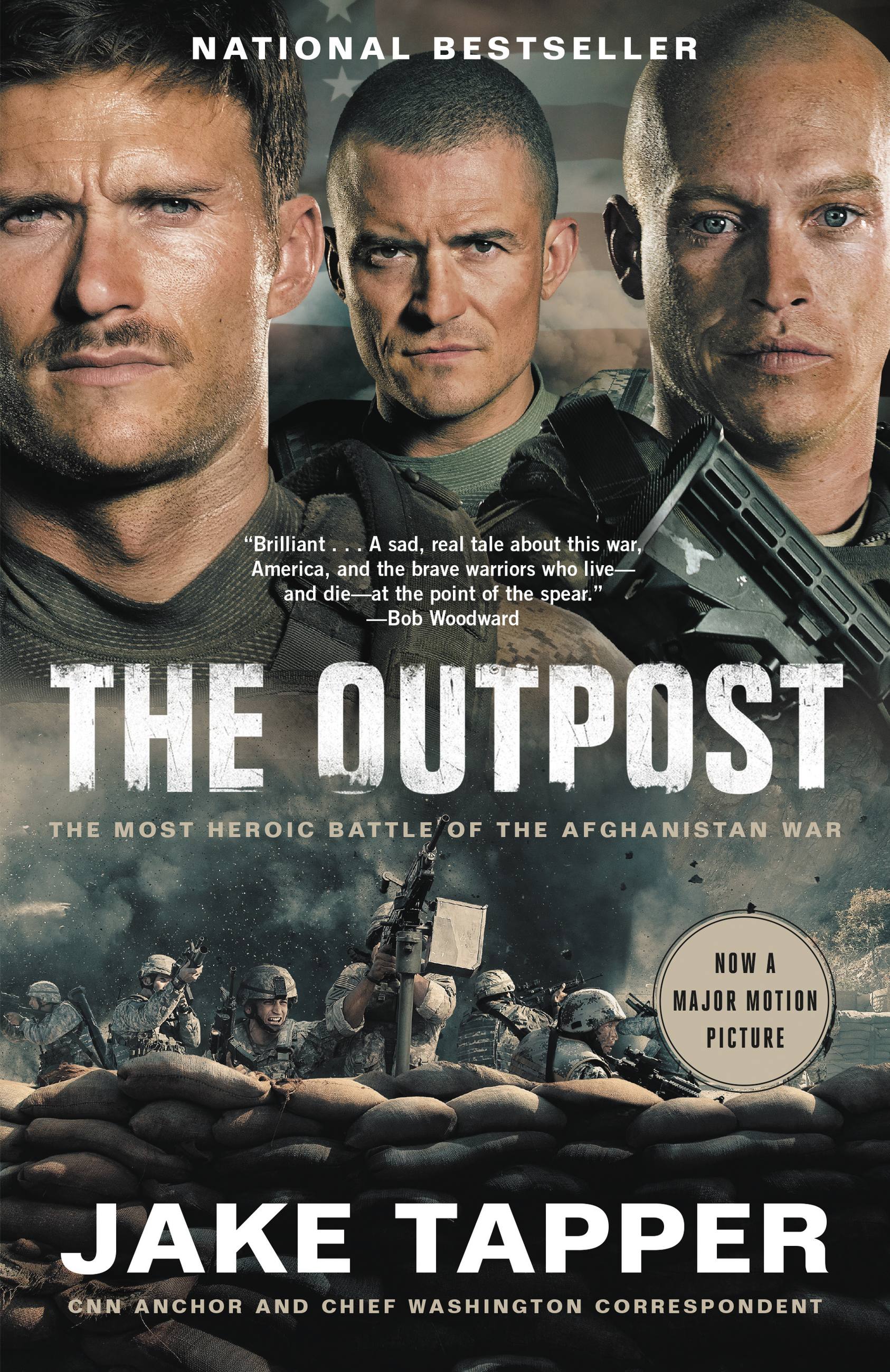
The Outpost The basis of the film starring Orlando Bloom and Scott Eastwood, The Outpost is the heartbreaking and inspiring story of one of America's deadliest battles during the war in Afghanistan, acclaimed by critics everywhere as a classic. At 5:58 AM on October 3rd, 2009, Combat Outpost Keating, located in frighteningly vulnerable terrain in Afghanistan just 14 miles from the Pakistani border, was viciously attacked. Though the 53 Americans there prevailed against nearly 400 Taliban fighters, their casualties made it the deadliest fight of the war for the U.S. that year. Four months after the battle, a Pentagon review revealed that there was no reason for the troops at Keating to have been there in the first place. In The Outpost, Jake Tapper gives us the powerful saga of COP Keating, from its establishment to eventual destruction, introducing us to an unforgettable cast of soldiers and their families, and to a place and war that has remained profoundly distant to most Americans. A runaway bestseller, it makes a savage war real, and American courage manifest. "The Outpost is a mind-boggling, all-too-true story of heroism, hubris, failed strategy, and heartbreaking sacrifice. If you want to understand how the war in Afghanistan went off the rails, you need to read this book." -- Jon Krakauer POLITICAL SCIENCE,Terrorism

Deterring Terrorism Deterring Terrorism brings together prominent theorists to discuss the topic of deterrence in counterterrorism, offering a comprehensive overview of both the theory and practice. POLITICAL SCIENCE,Terrorism
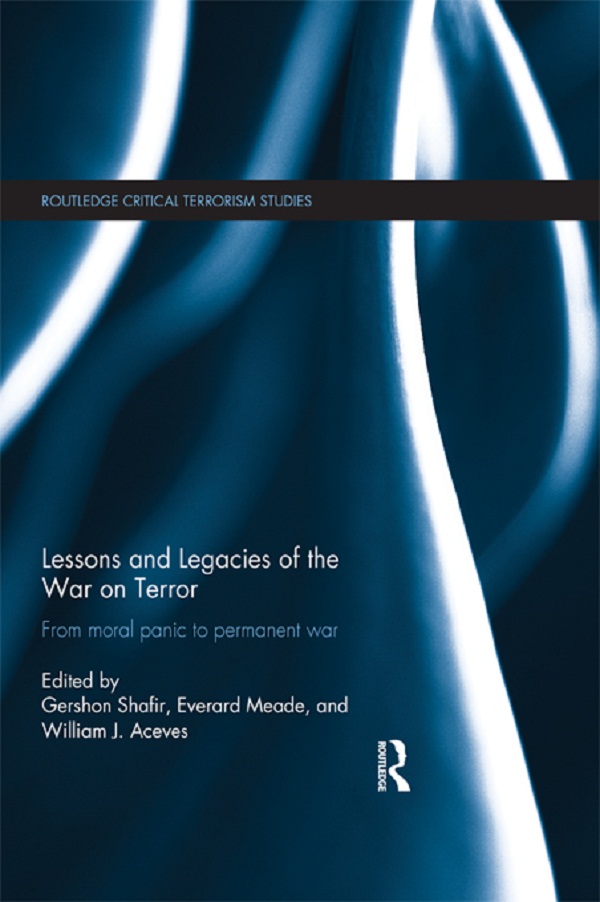
Lessons and Legacies of the War On Terror This volume examines the lessons and legacies of the U.S.-led "Global War on Terror," utilizing the framework of a political "moral panic." A decade after 9/11, it is increasingly difficult to deny that terror has prevailed – not as a specific enemy, but as a way of life. Transport, trade, and communications are repeatedly threatened and disrupted worldwide. While the pace and intensity of terror attacks have abated, many of the temporary security measures and sacrifices of liberty adopted in their immediate aftermath have become more or less permanent. This book examines the social, cultural, and political drivers of the war on terror through the framework of a "political moral panic": the exploration of threats to particular individuals or institutions that come to be viewed as threats to a way of life, social norms and values, civilization, and even morality itself. Drawing upon a wide range of domestic and international case studies, this volume reinforces the need for reason, empathy, and a dogged defence of principle in the face of terror. This book will be of much interest to students of terrorism studies, human rights, U.S. foreign policy, American politics, and Security Studies and I.R. in general. POLITICAL SCIENCE,Terrorism
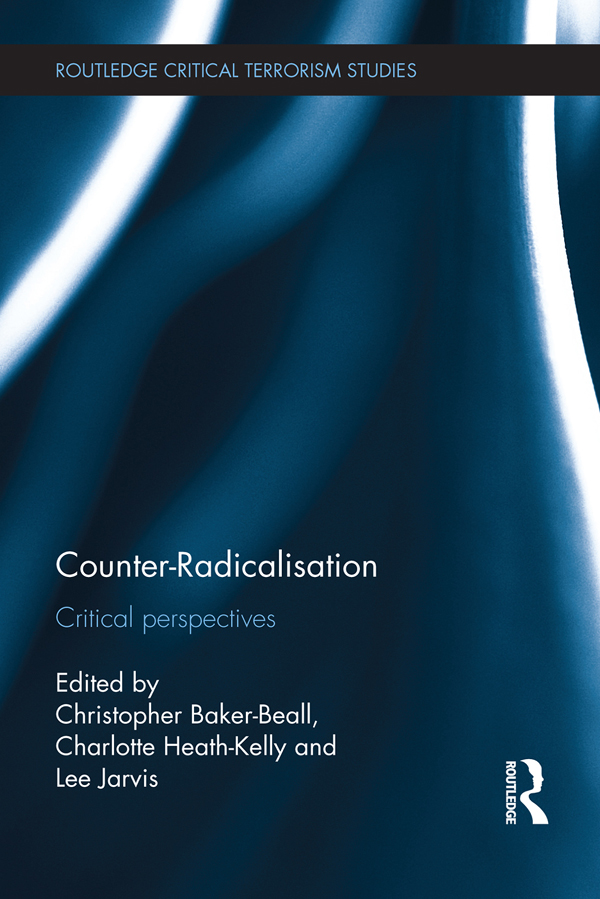
Counter-Radicalisation This book offers a wide-ranging and critical examination of recent counter-radicalisation policies, using case studies from several countries. Counter-radicalisation policies, such as the UK ‘Prevent’ strategy, have been highly controversial and increasingly criticised since their introduction. In this edited volume, voices from disciplines including sociology, political science, criminology and International Relations are brought together to address issues across the global roll-out of counter-radicalisation agendas. In so doing, the book critically interrogates: (i) the connections between counter-radicalisation and other governmental programmes and priorities relating to integration and community cohesion; (ii) the questionable dependence of counter-radicalisation initiatives on discourses and assumptions about race, risk and vulnerability to extremism; and, (iii) the limitations of existing counter-radicalisation machineries for addressing relatively new types of extremism including amongst ‘right-wing’ activists. Through examining these questions, the book draws on a range of contemporary case studies spanning from counter-radicalisation in the UK, Germany and Denmark, through to detailed analyses of specific preventative initiatives in Australia and the United States. Conceptually, the chapters engage with a range of critical approaches, including discourse theory, autoethnography and governmentality. This book will be of much interest to students of radicalisation, critical terrorism studies, counter-terrorism, sociology, security studies and IR in general. POLITICAL SCIENCE,Terrorism

Counterterrorism Global terrorism in the 21st century threatens the foundations of secular democracies and directly challenges global security thereby raising new and critical issues that transcend national borders. This two-volume reference carefully examines threats such as Weapons of Mass Destruction (WMD) terrorism, agro-environmental terrorism, and energy-related terrorism, and discusses technologies and strategies—such as the use of biometrics, data mining, information systems, psychological profiling, and terrorists rehabilitation efforts—to mitigate these threats. Counterterrorism: From the Cold War to the War on Terror provides an easy-to-read discussion of some of the principal issues involved in combating contemporary terrorism. Information is presented in non-technical language, making it appealing to the general reader as well as a solid reference for undergraduate college students and researchers. Following each article are references to other articles of interest and a comprehensive index facilitates access to specific subject material. The second volume includes a compilation of significant national and international treaties, laws, conventions, and protocols that have been implemented in an attempt to counter these ongoing threats to domestic and international security. POLITICAL SCIENCE,Terrorism
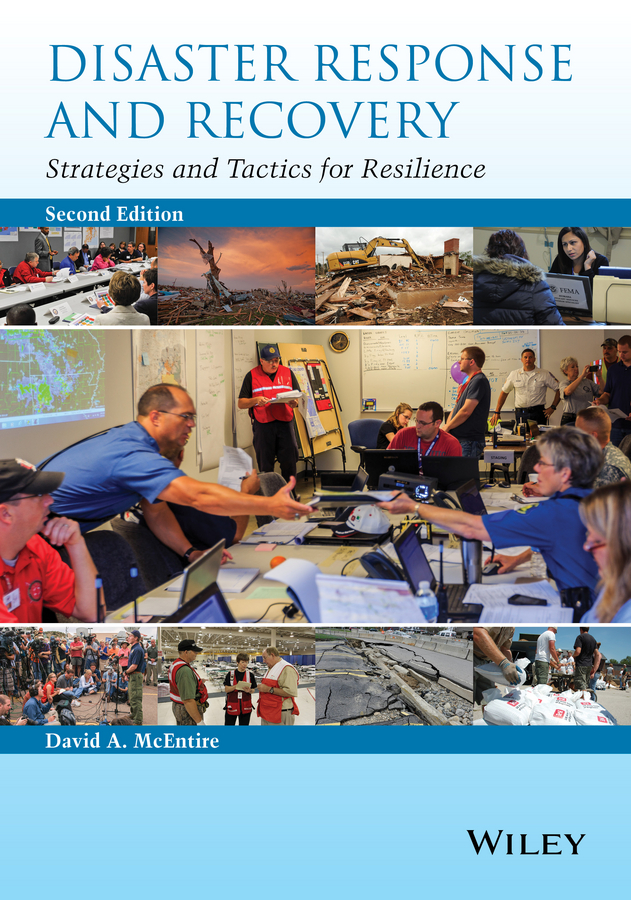
Disaster Response and Recovery Provides an overview of the various types of disasters that may occur, the myriad of actors that are involved in emergency management, and the diverse theoretical frameworks from which post-disaster activities may be approached. • Includes updated chapters keeping the material fresh and accessible while incorporating recent changes in policy and new research • Highlights lessons learned from such incidents and catastrophes as: Hurricane Katrina, Earthquake in Haiti, Parking lot collapse in Miami, West Texas industrial explosion, Train wreck in Spain, Aurora movie shooting, Times Square bombing, etc. • Examines typical challenges to be expected during response efforts along with tools and techniques to enhance the ability to protect lives, reduce property damage and minimize disruption • Includes an instructor package which contains: Sample Syllabus, Teaching Suggestions, Test bank, and PowerPoints POLITICAL SCIENCE,Terrorism
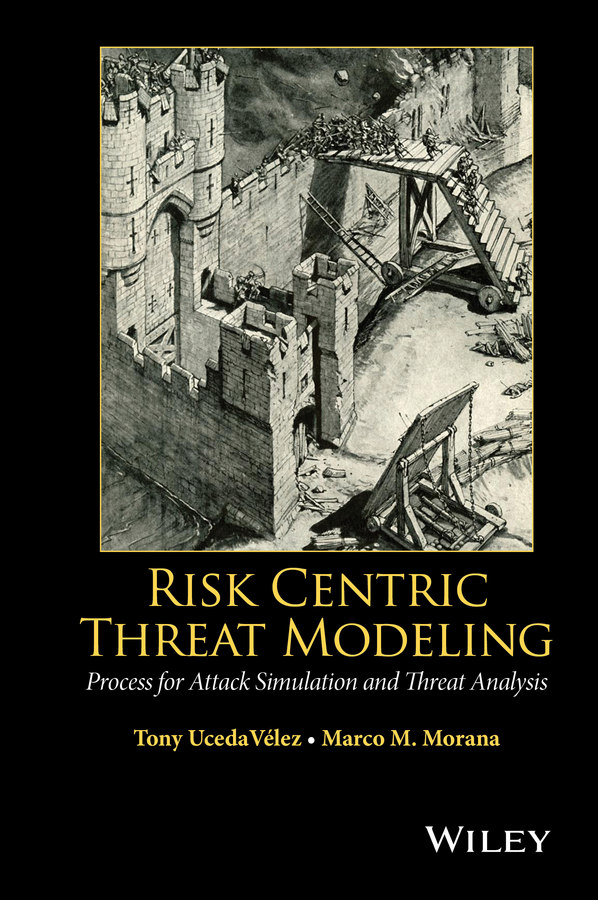
Risk Centric Threat Modeling This book introduces the Process for Attack Simulation & Threat Analysis (PASTA) threat modeling methodology. It provides an introduction to various types of application threat modeling and introduces a risk-centric methodology aimed at applying security countermeasures that are commensurate to the possible impact that could be sustained from defined threat models, vulnerabilities, weaknesses, and attack patterns. This book describes how to apply application threat modeling as an advanced preventive form of security. The authors discuss the methodologies, tools, and case studies of successful application threat modeling techniques. Chapter 1 provides an overview of threat modeling, while Chapter 2 describes the objectives and benefits of threat modeling. Chapter 3 focuses on existing threat modeling approaches, and Chapter 4 discusses integrating threat modeling within the different types of Software Development Lifecycles (SDLCs). Threat modeling and risk management is the focus of Chapter 5. Chapter 6 and Chapter 7 examine Process for Attack Simulation and Threat Analysis (PASTA). Finally, Chapter 8 shows how to use the PASTA risk-centric threat modeling process to analyze the risks of specific threat agents targeting web applications. This chapter focuses specifically on the web application assets that include customer’s confidential data and business critical functionality that the web application provides. • Provides a detailed walkthrough of the PASTA methodology alongside software development activities, normally conducted via a standard SDLC process • Offers precise steps to take when combating threats to businesses • Examines real-life data breach incidents and lessons for risk management Risk Centric Threat Modeling: Process for Attack Simulation and Threat Analysis is a resource for software developers, architects, technical risk managers, and seasoned security professionals. POLITICAL SCIENCE,Terrorism
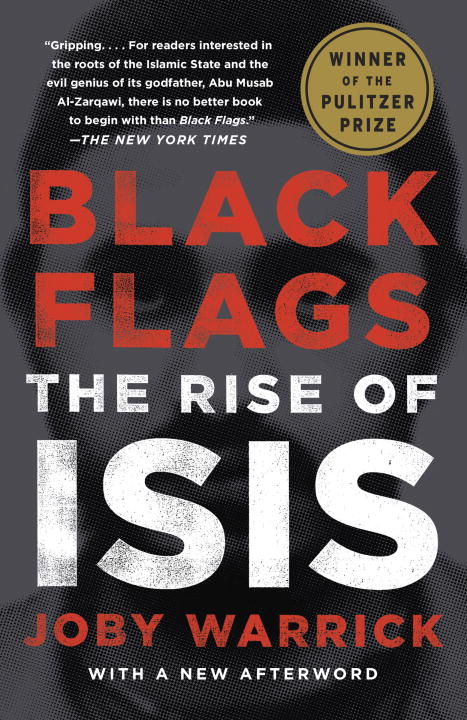
Black Flags WINNER OF THE 2016 PULITZER PRIZE FOR GENERAL NONFICTION “A Best Book of 2015”—The New York Times, The Washington Post, People Magazine, San Francisco Chronicle, Kansas City Star, and Kirkus Reviews In a thrilling dramatic narrative, awarded the 2016 Pulitzer Prize for General Nonfiction, Joby Warrick traces how the strain of militant Islam behind ISIS first arose in a remote Jordanian prison and spread with the unwitting aid of two American presidents. When the government of Jordan granted amnesty to a group of political prisoners in 1999, it little realized that among them was Abu Musab al-Zarqawi, a terrorist mastermind and soon the architect of an Islamist movement bent on dominating the Middle East. In Black Flags, an unprecedented character-driven account of the rise of ISIS, Pulitzer Prize-winning reporter Joby Warrick shows how the zeal of this one man and the strategic mistakes of Presidents Bush and Obama led to the banner of ISIS being raised over huge swaths of Syria and Iraq. Zarqawi began by directing terror attacks from a base in northern Iraq, but it was the American invasion in 2003 that catapulted him to the head of a vast insurgency. By falsely identifying him as the link between Saddam and bin Laden, U.S. officials inadvertently spurred like-minded radicals to rally to his cause. Their wave of brutal beheadings and suicide bombings persisted until American and Jordanian intelligence discovered clues that led to a lethal airstrike on Zarqawi’s hideout in 2006. His movement, however, endured. First calling themselves al-Qaeda in Iraq, then Islamic State of Iraq and Syria, or ISIS, his followers sought refuge in unstable, ungoverned pockets on the Iraq-Syria border. When the Syrian civil war broke out in 2011, and as the U.S. largely stood by, ISIS seized its chance to pursue Zarqawi’s dream of an ultra-conservative Islamic caliphate. Drawing on unique high-level access to CIA and Jordanian sources, Warrick weaves gripping, moment-by-moment operational details with the perspectives of diplomats and spies, generals and heads of state, many of whom foresaw a menace worse than al Qaeda and tried desperately to stop it. Black Flags is a brilliant and definitive history that reveals the long arc of today’s most dangerous extremist threat. POLITICAL SCIENCE,Terrorism
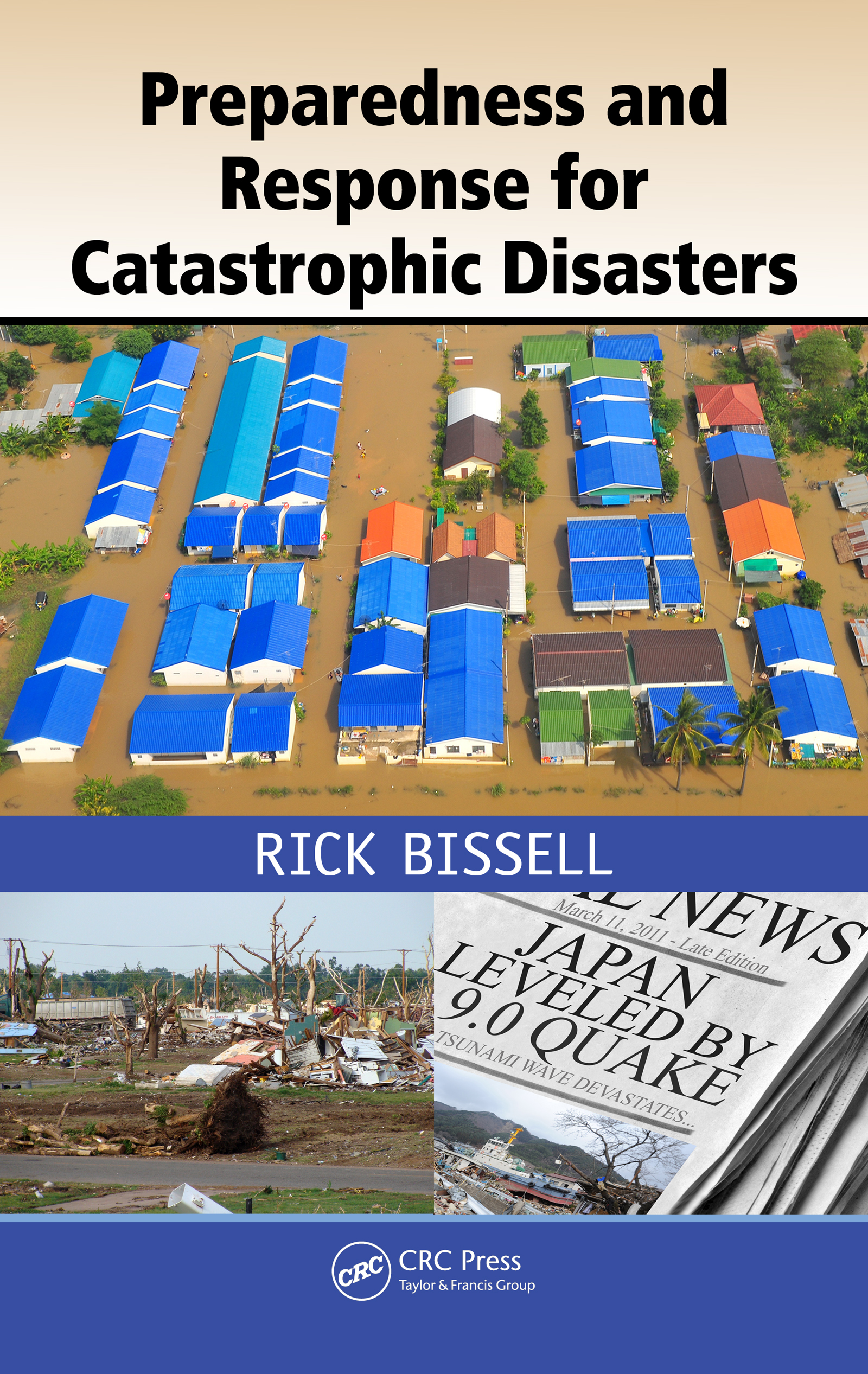
Preparedness and Response for Catastrophic Disasters Based on a popular course for the FEMA Higher Education project, Preparedness and Response for Catastrophic Disasters provides important insight into plans to mitigate and respond to the devastation caused by large-scale catastrophic events. Hurricane Katrina provided clear evidence that these occurrences are both qualitatively and quantitatively different from other disasters. Recent tragedies, like the 2004 South Asia tsunami, the 2010 earthquake in Haiti, and the 2011 earthquake, tsunami, and resulting nuclear plant meltdown in Japan further illustrate that we are not prepared for such events. Written by top disaster scholars and practitioners, the book defines what constitutes a catastrophic event, outlining both the factors that can lead to catastrophes and the unique logistical, planning, and response challenges posed by them. Distinct from general disasters, these events are termed "catastrophic" due to the regional impact, impacts to logistics and infrastructure, the devastating effects on large-scale populations, and the ripple effects on regional and global economies. Preparedness and Response for Catastrophic Disasters examines why catastrophes must be approached differently. If governments, public administrators, and emergency management professionals are to succeed in protecting our populations, there must be consensus, decisiveness, and leadership in both the coordination and response. In addition, there must be a fundamental recognition that catastrophic events compromise the very infrastructure—public utilities, delivery of goods and service, schools, business functions, and government—that supports communities and upon which modern society is based. As such, the book explores how catastrophes can dramatically affect populations and addresses new, innovative, and fundamentally unique strategies communities can institute to better prepare populations for catastrophic events and their aftermath. POLITICAL SCIENCE,Terrorism

The Impact, Legitimacy and Effectiveness of EU Counter-Terrorism Counter-terrorism law and policy has been prominent and widespread in the years following 9/11, touching on many areas of everyday life from policing and border control to financial transactions and internet governance. The European Union is a major actor in contemporary counter-terrorism, including through its development of counter-terrorism laws for application within the Union. This book undertakes a multi-disciplinary and empirically informed analysis of the impact, legitimacy and effectiveness of EU counter-terrorism. Taking into account legal, societal, operational and democratic perspectives, this collection connects theoretical and practical perspectives to produce an interdisciplinary and multi-stakeholder study of how we might measure and understand the impact, legitimacy and effectiveness of EU counter-terrorism. Bringing together a select group of experts in the field, particular emphasis is placed on understanding the practical experience of implementing and assessing these measures gathered from and with end users, including law-makers, policy-makers, security services, industry partners and civil society. This edited collection will be of great relevance to scholars and policy makers with an interest in counter-terrorism law, EU law and security studies. POLITICAL SCIENCE,Terrorism
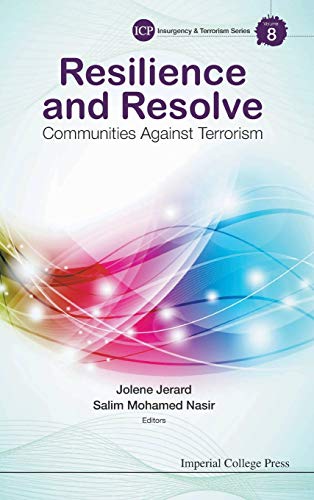
Resilience And Resolve This book aims to provide an overview of the importance of communities to mitigate the threat of terrorism, drawing key lessons and experiences from countries adopting community-based approaches. There has been growing recognition among countries to understand the construct of radical ideology and the tools needed to counter its narrative through a more socially inclusive approach, using communities as key stakeholders that have the resolve to be resilient in the fight against terrorism. The chapters provide invaluable insights on the psychological aspects of radicalization, the centrality of counter-ideology and case studies of approaches to promoting moderation, religious harmony and community engagement in building the resilience and resolve against terrorism. POLITICAL SCIENCE,Terrorism

Enhanced Interrogation In the dark days immediately after 9/11, the CIA turned to Dr. James Mitchell to help craft an interrogation program designed to elicit intelligence from just-captured top al-Qa'ida leaders and terror suspects. A civilian contractor who had spent years training U.S. military members to resist interrogation should they be captured, Mitchell, aware of the urgent need to prevent impending catastrophic attacks, worked with the CIA to implement "enhanced interrogation techniques"--which included waterboarding. In Enhanced Interrogation, Mitchell now offers a first-person account of the EIT program, providing a contribution to our historical understanding of one of the most controversial elements of America's ongoing war on terror. Readers will follow him inside the secretive "black sites" and cells of terrorists and terror suspects where he personally applied enhanced interrogation techniques. Mitchell personally questioned thirteen of the most senior high-value detainees in U.S. custody, including Abu Zubaydah; Abd al-Rahim al-Nashiri, the amir or "commander" of the USS Cole bombing; and Khalid Sheikh Mohammed, the mastermind behind the September 11, 2001, terror attacks--obtaining information that he maintains remains essential to winning the war against al-Qa'ida and informing our strategy to defeat ISIS and all of radical Islam. From the interrogation program's earliest moments to its darkest hours, Mitchell also lifts the curtain on its immediate effects, the controversy surrounding its methods, and its downfall. He shares his view that EIT, when applied correctly, were useful in drawing detainees to cooperate, and that, when applied incorrectly, they were counter-productive. He also chronicles what it is like to undertake a several-years-long critical mission at the request of the government only to be hounded for nearly a decade afterward by congressional investigations and Justice Department prosecutors. Gripping in its detail and deeply illuminating, Enhanced Interrogation argues that it is necessary for America to take strong measures to defend itself from its enemies and that the country is less safe now without them than it was before 9/11. POLITICAL SCIENCE,Terrorism

Violence in the Skies Aviation security expert Philip Baum delves into the history of flying to reveal the stories behind the most astonishing and shocking crimes in our skies, calling on testimony from hijackers, crew members, passengers and politicians. This account of global aviation sabotage is authoritatively comprehensive and unforgettably thrilling. POLITICAL SCIENCE,Terrorism
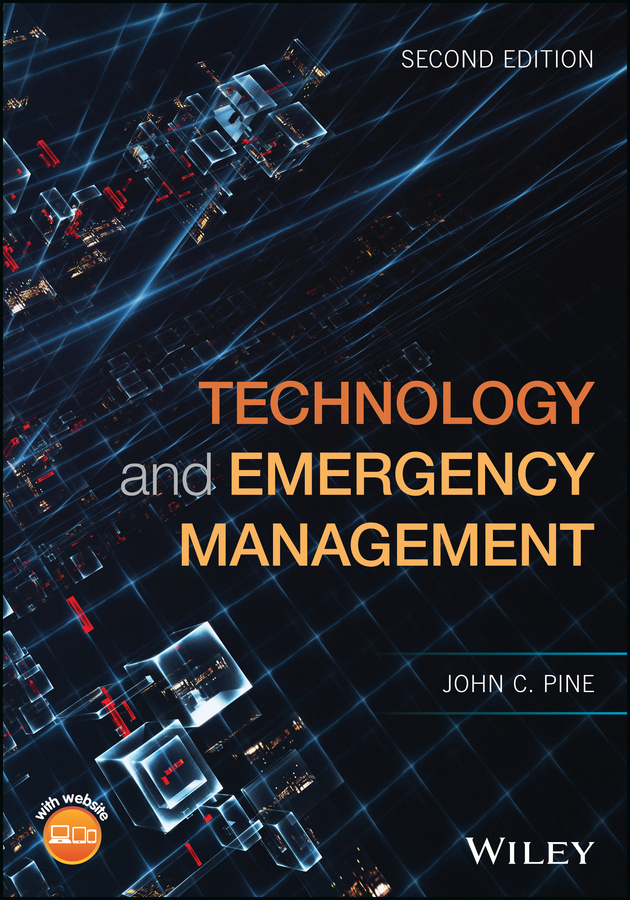
Technology and Emergency Management The first book devoted to a critically important aspect of disaster planning, management, and mitigation Technology and Emergency Management, Second Edition describes best practices for technology use in emergency planning, response, recovery, and mitigation. It also describes the key elements that must be in place for technology to enhance the emergency management process. The tools, resources, and strategies discussed have been applied by organizations worldwide tasked with planning for and managing every variety of natural and man-made hazard and disaster. Illustrative case studies based on their experiences appear throughout the book. This new addition of the critically acclaimed guide has been fully updated and expanded to reflect significant developments occurring in the field over the past decade. It features in-depth coverage of major advances in GIS technologies, including the development of mapping tools and high-resolution remote sensing imaging. Also covered is the increase in computer processing power and mobility and enhanced analytical capabilities for assessing the present conditions of natural systems and extrapolating from them to create accurate models of potential crisis conditions. This second edition also features a new section on cybersecurity and a new chapter on social media and disaster preparedness, response, and recovery has been added. Explores the role of technology in emergency planning, response, recovery, and mitigation efforts Explores applications of the Internet, telecommunications, and networks to emergency management, as well as geospatial technologies and their applications Reviews the elements of hazard models and the relative strengths and weaknesses of modeling programs Describes techniques for developing hazard prediction models using direct and remote sensing data Includes test questions for each chapter, and a solutions manual and PowerPoint slides are available on a companion website Technology and Emergency Management, Second Edition is a valuable working resource for practicing emergency managers and an excellent supplementary text for undergraduate and graduate students in emergency management and disaster management programs, urban and regional planning, and related fields. POLITICAL SCIENCE,Terrorism

Jihadi Terrorism and the Radicalisation Challenge Osama bin Laden's demise in May 2011 marked only the symbolic end of an era. By the time of his killing, he no longer represented the Robin Hood icon that once stirred global fascination. Ten years after the 11 September 2001 attacks, jihadi terrorism has largely lost its juggernaut luster. It now mostly resembles a patchwork of self-radicalising local groups with international contacts but without any central organisational design - akin to the radical left terrorism of the 1970s and the anarchist fin-de-siècle terrorism. This volume addresses two issues that remain largely unexplored in contemporary terrorism studies. It rehabilitates the historical and comparative analysis as a way to grasp the essence of terrorism, including its jihadi strand. Crucial similarities with earlier forms of radicalisation and terrorism abound and differences appear generally not fundamental. Likewise, the very concept of radicalisation is seldom questioned anymore. Nevertheless it often lacks conceptual clarity and empirical validation. Once considered a quintessential European phenomenon, the United States too experiences how some of its own citizens radicalise into terrorist violence. This collective work compares radicalisation in both continents and the strategies aimed at de-radicalisation. But it also assesses if the concept merits its reputation as the holy grail of terrorism studies. The volume is aimed at an audience of decision makers, law enforcement officials, academia and think tanks, by its combination of novel thinking, practical experience and a theoretical approach. POLITICAL SCIENCE,Terrorism
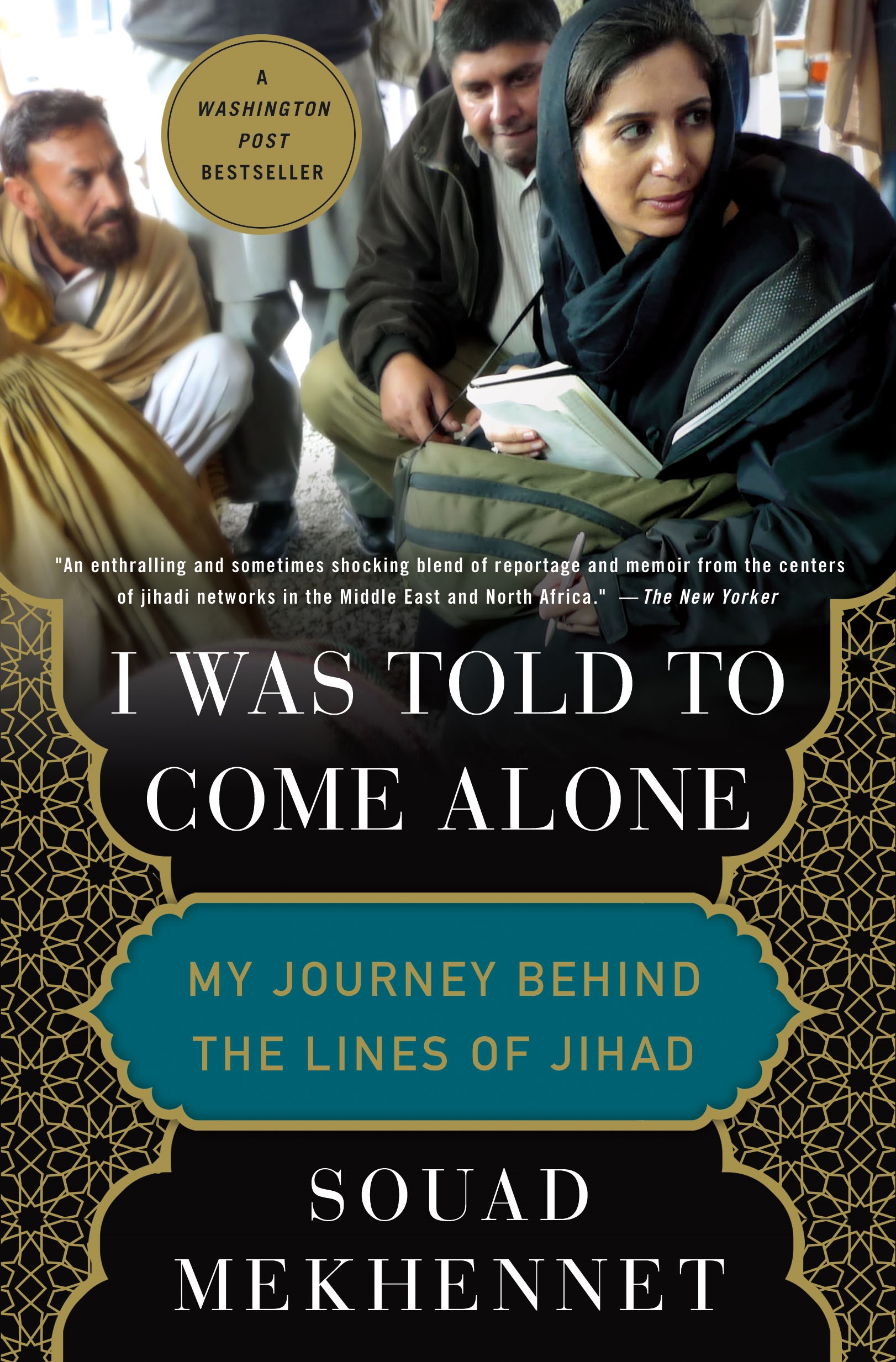
I Was Told to Come Alone “I was told to come alone. I was not to carry any identification, and would have to leave my cell phone, audio recorder, watch, and purse at my hotel. . . .†For her whole life, Souad Mekhennet, a reporter for The Washington Post who was born and educated in Germany, has had to balance the two sides of her upbringing – Muslim and Western. She has also sought to provide a mediating voice between these cultures, which too often misunderstand each other. In this compelling and evocative memoir, we accompany Mekhennet as she journeys behind the lines of jihad, starting in the German neighborhoods where the 9/11 plotters were radicalized and the Iraqi neighborhoods where Sunnis and Shia turned against one another, and culminating on the Turkish/Syrian border region where ISIS is a daily presence. In her travels across the Middle East and North Africa, she documents her chilling run-ins with various intelligence services and shows why the Arab Spring never lived up to its promise. She then returns to Europe, first in London, where she uncovers the identity of the notorious ISIS executioner “Jihadi John,†and then in France, Belgium, and her native Germany, where terror has come to the heart of Western civilization. Mekhennet’s background has given her unique access to some of the world’s most wanted men, who generally refuse to speak to Western journalists. She is not afraid to face personal danger to reach out to individuals in the inner circles of Al Qaeda, the Taliban, ISIS, and their affiliates; when she is told to come alone to an interview, she never knows what awaits at her destination. Souad Mekhennet is an ideal guide to introduce us to the human beings behind the ominous headlines, as she shares her transformative journey with us. Hers is a story you will not soon forget. POLITICAL SCIENCE,Terrorism

American Radical THE NEW YORK TIMES BESTSELLER The explosive memoir of a Muslim American FBI agent fighting terror from the inside. It’s no secret that federal agencies are waging a broad, global war against terror. But for the first time in this memoir, an active Muslim American federal agent reveals his experience infiltrating and bringing down a terror cell in North America. A longtime undercover agent, Tamer Elnoury joined an elite counterterrorism unit after September 11. Its express purpose is to gain the trust of terrorists whose goals are to take out as many Americans in as public and as devastating a way possible. It's a furious race against the clock for Tamer and his unit to stop them before they can implement their plans. Yet as new as this war still is, the techniques are as old as time: listen, record, and prove terrorist intent. Due to his ongoing work for the FBI, Elnoury writes under a pseudonym. An Arabic-speaking Muslim American, a patriot, a hero: To many Americans, it will be a revelation that he and his team even exist, let alone the vital and dangerous work they do keeping all Americans safe. POLITICAL SCIENCE,Terrorism

Terrorism and the Politics of Fear This text explains how the social construction of fear is used to steer public and foreign policy, arguing that security policies to protect the citizenry have become control systems that curtail privacy and civil liberties. It has been updated with analysis of recent events, ranging from Israeli-Hamas wars to the growing impact of social media. POLITICAL SCIENCE,Terrorism

Contemporary Debates on Terrorism Contemporary Debates on Terrorism is an innovative textbook, addressing a number of key issues in terrorism studies from both traditional and 'critical' perspectives. This second edition has been revised and updated to cover contemporary issues such as the rise of ISIL and cyberterrorism. In recent years, the terrorism studies field has grown in quantity and quality, with a growing number of scholars rooted in various professional disciplines beginning to debate the complex dynamics underlying this category of violence. Within the broader field, there are a number of identifiable controversies and questions which divide scholarly opinion and generate opposing arguments. These relate to theoretical issues, such as the definition of terrorism and state terrorism, substantive issues like the threat posed by al Qaeda/ISIL and the utility of different responses to terrorism, different pathways leading people to engage in terrorist tactics and ethical issues such as the use of drones. This new edition brings together in one place many of the field’s leading scholars to debate the key issues relating to a set of 16 important controversies and questions. The format of the volume involves a leading scholar taking a particular position on the controversy, followed by an opposing or alternative viewpoint written by another scholar. In addition to the pedagogic value of allowing students to read opposing arguments in one place, the volume will also be important for providing an overview of the state of the field and its key lines of debate. This book will be essential reading for students of terrorism studies and political violence, critical terrorism studies, security studies and IR in general. POLITICAL SCIENCE,Terrorism

The Axis of Evil In the nearly 25 years since the ascent of an Islamic regime, Iran has become one of the most prominent supporters of terror worldwide. Today Iran actively employs terror to achieve its international objectives. The Axis of Evil outlines the operations and goals of Shiite and Iranian terror. As Shaul Shay shows, Iran has done its utmost to conceal its involvement in terror activities and avoids leaving incriminating "fingerprints" that might prompt retaliatory action by victims of this terrorism. In consequence, most of what we know about Iranian terror activity has been gleaned from the capture and trials of Iranian terrorists or terrorists acting on Iran's behalf. The Axis of Evil deals extensively with Iran's involvement in terrorist activity against Israel through Hizballah after the Israel Defense Forces' withdrawal from Lebanon (May 2000) and the instigation of the Al-Aksa Intifada (September 2000-2003). It examines Iran's attitude towards the State of Israel since the rise of Knomeini, confirming that Iran sees Israel as a primary source of the world's wrongdoings and the epitome of evil. In turn, Israel has become one of Iran's archenemies. Over the years, Iran has strengthened its ideological links with radical Arab and Palestinian circles. In addition, it actively supports Hizballah, which acts on behalf of Iran from its base in Lebanon and perpetrates terror attacks against Israel and against representatives of Western and Arab countries in Lebanon as well as in the international arena. This book is a comprehensive and in-depth study of Shiite and Iranian terror activity. In addition to drawing attention to the significance of Iran's contributions to terror, it provides readers with a better understanding of Iran's activities in light of the global war against terrorism as well as the deployment of American troops along Iran's borders with Afghanistan and Iraq. POLITICAL SCIENCE,Terrorism

Terrorism A comprehensive investigation of modern terrorism and the global terrorist environment, topics discussed include the Causes of Terrorism, the Role of the Media, Cyberterrorism, Religious Terrorism, and The Future of Terrorism. POLITICAL SCIENCE,Terrorism
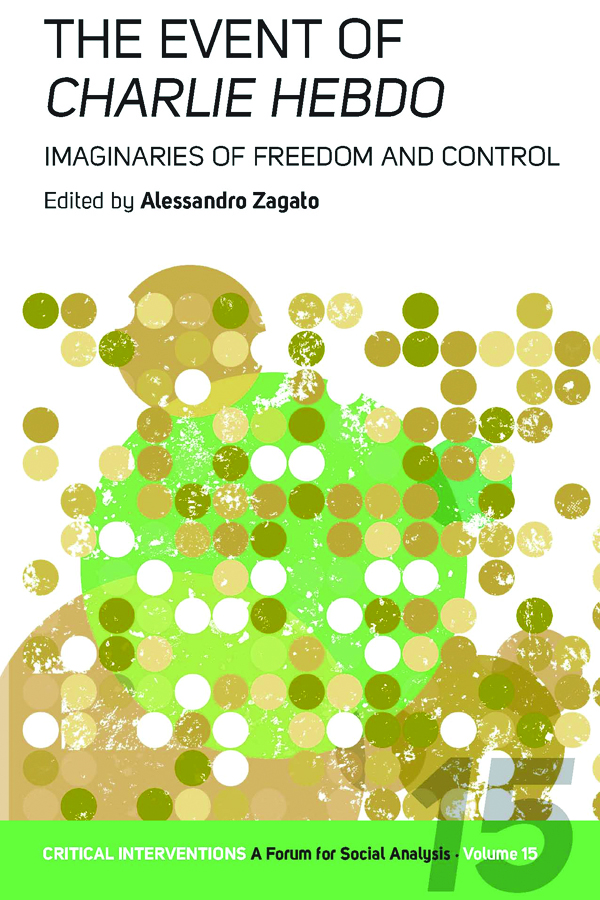
The Event of Charlie Hebdo The January 2015 shooting at the headquarters of satirical magazine Charlie Hebdo in Paris and the subsequent attacks that took place in the ÃŽle-de-France region were staggeringly violent events. They sparked an enormous discussion among citizens and intellectuals from around Europe and beyond. By analyzing the effects the attacks have had in various spheres of social life, including the political, ideology, collective imaginaries, the media, and education, this collection of essays aims to serve as a contribution as well as a critical response to that discussion. The volume observes that the events being attributed to Charlie Hebdo go beyond sensationalist reports of the mainstream media, transcend the spatial confines of nation states, and lend themselves to an ever-expanding number of mutating discursive formations. POLITICAL SCIENCE,Terrorism

Countering Terrorism Can We Construct a Grand Strategy to Counter Terrorism? Fifteen years after September 11, the United States still faces terror threatsboth domestic and foreign. After years of wars, ever more intensive and pervasive surveillance, enhanced security measures at major transportation centers and many attempts to explain who we are fighting and why and how to fight them, the threats continue to multiply. So, too, do our attempts to understand just what terrorism is and how to counter it. Two leaders in the field of terrorism studies, Martha Crenshaw and Gary LaFree, provide a critical look at how we have dealt with the terror threat over the years. They make clear why it is so difficult to create policy to counter terrorism. The foes are multiple and often amorphous, the study of the field dogged by disagreement on basic definitional and methodological issues, and the creation of policy hobbled by an exacting standard: the counterterrorist must succeed all the time, the terrorist only once. As Countering Terrorism shows, there are no simple solutions to this threat. POLITICAL SCIENCE,Terrorism

Islam and Sectarian Violence in Pakistan This book analyses the growth of sectarian-based terrorist violence in Pakistan, one of the Muslim majority states most affected by sectarian violence, ever since it was established in 1947. Sectarian violence among Muslims has emerged as a major global security problem in recent years. The author argues that the upsurge in sectarian violence in Pakistan, particularly since the late 1970s, has had less to do with theological differences between the various sects of Islam, but is a consequence of the specific political, social, economic, demographic and cultural changes that have taken place in Pakistan since it was established as an independent state. A major theme of the book is the increasing violence, extent and expressions of sectarian conflict which have emerged as new forms of sectarian terrorism. The volume provides an in-depth empirical case study which addresses some major theoretical questions raised by Critical Terrorism Studies researchers in respect of the links between religion and sectarian terrorism in Pakistan and more widely. This book will be of much interest to students of critical terrorism studies, Asian politics and history, religious studies and International Relations in general. POLITICAL SCIENCE,Terrorism

Inside Al-Shabaab - One of the most powerful Islamic groups in Africa with connections to Al-Qaeda. - Draws on interviews from former Al-Shabaab militants and commanders, US relations to the group and the 2006 US invasion of Somalia. - Well-written, the book will offer a n POLITICAL SCIENCE,Terrorism

Jihadism, Foreign Fighters and Radicalization in the EU Jihadism, Foreign Fighters and Radicalization in the EU addresses the organizational and strategic changes in terrorism in Europe as a result of urban jihadism and the influx of foreign fighters of European nationality or residence. Examining the different types of responses to the treatment of radicalization and its consequences in the recruitment of young urban fighters and jihadists, this book offers a framework for understanding the process of violent radicalization. It critically analyses political and legal responses that have taken place within the European framework, whilst also examining a series of functional responses from social and behavioural psychology. This book then goes on to develop an explanatory model from an economic standpoint, exploring the need to adapt the fight against the financing of terrorism to the changes in the sources of financing jihadist cells and foreign fighters. Furthermore, the volume draws on experience from the prison sector to assess the process of radicalization and the possibilities of intervention. Taking an interdisciplinary approach, this book will be of great interest to students of terrorism and counter-terrorism, radicalization, European politics, radical Islam and security studies. POLITICAL SCIENCE,Terrorism

The Far-Right in Contemporary Australia This book is the first to elaborate on radical and extreme right movements in contemporary Australia. It brings together leading scholars to present cutting edge research on various facets and manifestations of Australia’s diverse far-right, which has gained unprecedented public presence and visibility since the mid-2010s. The thematic breadth of the chapters in this volume reflects the complexity of the far-right in Australia, ranging from the attitudes of far-right populist party voters and the role of far-right groups in anti-mosque protests, to online messaging and rhetoric of radical and extreme right-wing movements. The contributions are theoretically grounded and come from a range of disciplines, including media and cultural studies, sociology, politics, and urban studies, exploring issue of far-right activism on the micro and macro level, with both qualitative and quantitative research methods. POLITICAL SCIENCE,Terrorism

Boston's Bloody Marathon April 15, 2013. Before the Boston Marathon was over, few people cared who won or lost. Patriots Day, a day of festivities to celebrate the American Revolution, was about to become the latest nightmare in America's ongoing war on terrorism."The pungent smell of gunpowder hung in the air while shrapnel, ball bearings and nails littered the streets near the blast sites. Spectators left behind backpacks, cell phones and handmade signs with runners' names. Doctors at Brigham and Women's Hospital later treated one patient whose body had been pierced by 12 carpenter's nails."Although this book focuses on the bombings at the Boston Marathon, the victims and the prosecution of the prime suspect, it is equally about "lone wolf" terrorists. Lone wolves refer to terrorists who plot their attacks alone, usually with no organization to support them and no official links to violent groups. There is almost no way to know their next target until they strike. U.S. intelligence agencies call them perhaps the biggest terrorist threat to the United States and its allies. POLITICAL SCIENCE,Terrorism

A Belfast Child John Chambers was brought up on Belfast's notorious Loyalist Glencairn estate, during the height of the Troubles. From an early age he witnessed violence, hatred and horror as Northern Ireland tore itself apart in civil strife. Kneecapping, brutal murders, and even public tarring-and-feathering were simply a fact of life for the children on the estate. He thought he knew which side he was on, but although raised as a Loyalist, he was hiding a troubling secret: that his disappeared mother - whom he'd always been told was dead - was a Roman Catholic, 'the enemy'. In a memoir of rare power, John explores the dark heart of Northern Irish sectarianism in the seventies and eighties. With searing honesty and native Belfast wit, he describes the light and darkness of his unique childhood, and his teenage journey through mod culture and ultra-Loyalism, before an escape from Belfast to London - where, still haunted by the shadow of his fractured family history - he began a turbulent and hedonistic adulthood. A Belfast Child is a tale of divided loyalties, dark secrets and the scars left by hatred and violence on a proud city - but also a story of hope, healing and ultimate redemption for a family caught in the rising tide of the Troubles. POLITICAL SCIENCE,Terrorism

Terrorism Worldwide, 2018 This comprehensive worldwide study catalogs terrorist attacks in 2018, during which the Islamic State continued its decline from a quasi-government commanding territory the size of the United Kingdom to a more traditional terrorist network controlling just 1000 square miles. Yet IS still boasts 30,000 adherents in Syria and Iraq, with many others awaiting plans for attacks in their home nations. Organized by region and country, this volume covers domestic and international incidents around the world, outlining significant trends. The author offers several indicators of what to watch in the coming years. The single-year format allows readers access to the most up-to-date information on terrorism, while geographic focus more easily facilitates regional comparison. POLITICAL SCIENCE,Terrorism

Anti-american Terrorism One of the major international security concerns that surfaced in the post-World War II period was the emergence and evolution of international terrorism. The dominant theme in the evolution of this threat has been anti-American terrorism. No other country in the world has had its overseas interests subjected to the level, lethality, diversity, and geographic scope of international terrorist activity than the United States. This four-volume work recounts the development of this threat through 12 US presidential administrations over a 70-year period. It assesses the terrorist threat in the US and overseas and how the government has responded with counter-terrorism policies, strategies, programs, organizations, legislation, international conventions, executive orders, special operations units, and actions. The evolution of the field of terrorism in academia, think tanks, institutes, and the private sector over these 12 administrations is also chronicled. POLITICAL SCIENCE,Terrorism

Growing Fanaticism, Terrorism And Terrorist Outfits Terrorism is, in the broadest sense, the use of intentionally indiscriminate violence as a means to create terror among masses of people; or fear to achieve a religious or political aim. Terrorism involves the use or threat of violence and seeks to create fear, not just within the direct victims but among a wide audience. The book covers a lot of topics and on each topic it gives very comprehensive and in-depth review. The aim of the book is to generate an understanding of the growing fanaticism, terrorism and terrorist outfits. The purpose of this study is to focus attention on the types of individuals and groups that are prone to terrorism. POLITICAL SCIENCE,Terrorism

The Convenient Terrorist A startling spotlight on the darkest corners of America’s War on Terror,†where nothing is quite what it seems. The Convenient Terrorist is the definitive inside account of the capture, torture, and detention of Abu Zubaydah, the first high-value target†captured by the CIA after 9/11. But was Abu Zubaydah, who is still being indefinitely held by the United States under shadowy circumstances, the blue-ribbon capture that the Bush White House claimed he was? Authors John Kiriakou, who led the capture of Zubaydah, and Joseph Hickman, who took custody of him at Guantanamo, draw a far more complex and intriguing portrait of the al-Qaeda mastermind†who became a symbol of torture and the dark side†of US security. From a one-time American collaborator to a poster boy for waterboarding, Abu Zubaydah became a convenient terroristâ€a way for US authorities to sell their War on Terror†to the American people. POLITICAL SCIENCE,Terrorism
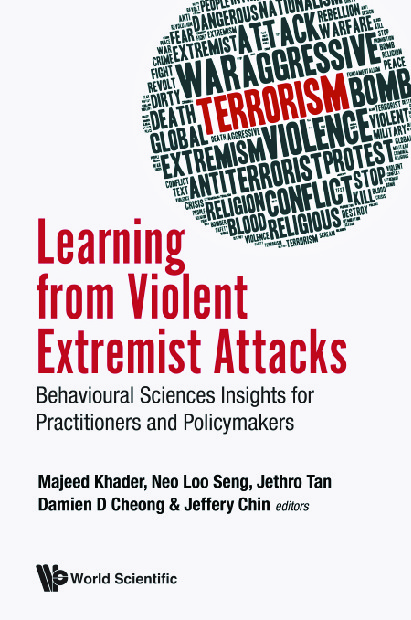
Learning From Violent Extremist Attacks How can we use psychology and the behavioural sciences to aid law enforcement to better identify violent extremists? What can we learn from past attacks to ensure that our society is more prepared? How can societies deal with tension after these attacks?Violent extremists are evolving, constantly honing their strategies to out-manuever the 'good guys'. Faced with the quandary, challenges, and responsibilities of ensuring the safety of the society, practitioners and policymakers have to take decisive steps to respond and mitigate the impact of an attack. However, the daunting task of countering violent extremism is still plagued by the lack of basic understanding of the phenomenon.This book, Learning from Violent Extremist Attacks: Behavioural Sciences Insights for Practitioners and Policymakers, attempts to fill a gap in the extant literature by offering a behavioural sciences approach to integrate our understanding of the threat of violent extremism, with knowledge drawn from diverse fields, such as psychology, sociology, history, political science, technology, and communications to identify the lessons learned and provide scientifically defensible interventions and approaches for both the practitioners and policymakers. POLITICAL SCIENCE,Terrorism
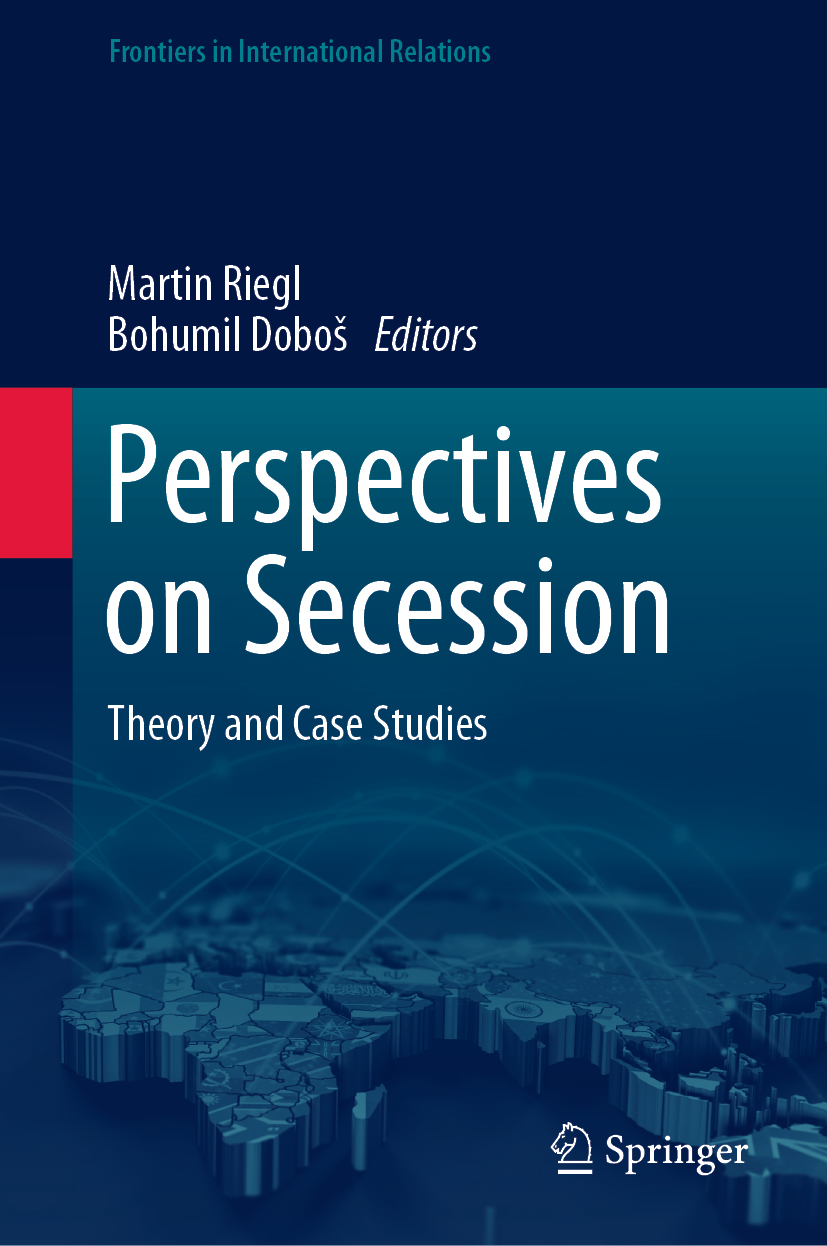
Perspectives on Secession This book explores the changing nature of secessionist attempts in connection with rapidly evolving geopolitical and technological landscapes. By presenting theoretical chapters as well as case studies on various secessionist movements around the globe, the contributing authors study a range of topics, including: the role of the media in secessionist conflicts; secessionist referenda and the viability of secessionist attempts in terms of their internal dimension; and external support and interference. The book will appeal to political scientists and international relations scholars who are interested in the processes, politics and geopolitical implications of secessionist movements. POLITICAL SCIENCE,Terrorism

Radical, Religious, and Violent Applying fresh tools from economics to explain puzzling behaviors of religious radicals: Muslim, Christian, and Jewish; violent and benign. How do radical religious sects run such deadly terrorist organizations? Hezbollah, Hamas, Lashkar-e-Taiba, and the Taliban all began as religious groups dedicated to piety and charity. Yet once they turned to violence, they became horribly potent, executing campaigns of terrorism deadlier than those of their secular rivals. In Radical, Religious, and Violent, Eli Berman approaches the question using the economics of organizations. He first dispels some myths: radical religious terrorists are not generally motivated by the promise of rewards in the afterlife (including the infamous seventy-two virgins) or even by religious ideas in general. He argues that these terrorists (even suicide terrorists) are best understood as rational altruists seeking to help their own communities. Yet despite the vast pool of potential recruits—young altruists who feel their communities are repressed or endangered—there are less than a dozen highly lethal terrorist organizations in the world capable of sustained and coordinated violence that threatens governments and makes hundreds of millions of civilians hesitate before boarding an airplane. What's special about these organizations, and why are most of their followers religious radicals? Drawing on parallel research on radical religious Jews, Christians, and Muslims, Berman shows that the most lethal terrorist groups have a common characteristic: their leaders have found a way to control defection. Hezbollah, Hamas, and the Taliban, for example, built loyalty and cohesion by means of mutual aid, weeding out “free riders” and producing a cadre of members they could rely on. The secret of their deadly effectiveness lies in their resilience and cohesion when incentives to defect are strong.These insights suggest that provision of basic social services by competent governments adds a critical, nonviolent component to counterterrorism strategies. It undermines the violent potential of radical religious organizations without disturbing free religious practice, being drawn into theological debates with Jihadists, or endangering civilians. POLITICAL SCIENCE,Terrorism
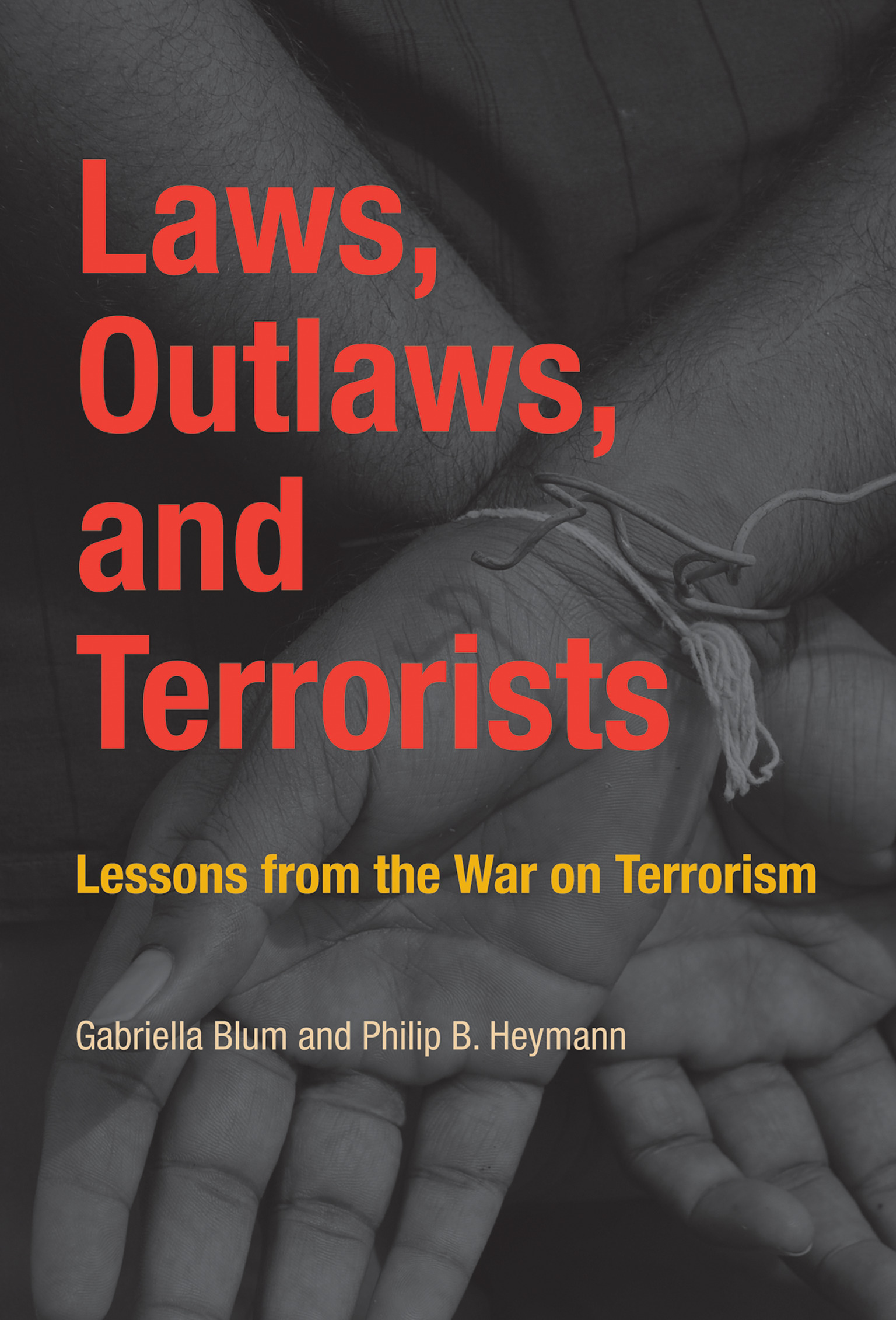
Laws, Outlaws, and Terrorists Guidance for maintaining national security without abandoning the rule of law and our democratic values. In an age of global terrorism, can the pursuit of security be reconciled with liberal democratic values and legal principles? During its “global war on terrorism,” the Bush administration argued that the United States was in a new kind of conflict, one in which peacetime domestic law was irrelevant and international law inapplicable. From 2001 to 2009, the United States thus waged war on terrorism in a “no-law zone.” In Laws, Outlaws, and Terrorists, Gabriella Blum and Philip Heymann reject the argument that traditional American values embodied in domestic and international law can be ignored in any sustainable effort to keep the United States safe from terrorism. They demonstrate that the costs are great and the benefits slight from separating security and the rule of law. They call for reasoned judgment instead of a wholesale abandonment of American values. They also argue that being open to negotiations and seeking to win the moral support of the communities from which the terrorists emerge are noncoercive strategies that must be included in any future efforts to reduce terrorism. POLITICAL SCIENCE,Terrorism

Defusing Armageddon The first in-depth examination of NEST: America's super-secret government agency operating to prevent nuclear terrorist attacks. Jeffrey T. Richelson reveals the history of the Nuclear Emergency Support Team, from the events leading to its creation in 1974 to today. Defusing Armageddon provides a behind-the-scenes look at NEST's personnel, operations, and detection and disablement equipment--employed in response to attempts at nuclear extortion, lost and stolen nuclear material, crashed nuclear-powered Soviet satellites, and al Qaeda's quest for nuclear weapons. Richelson traces the Cosmos satellite that crashed into the Canadian wilderness; nuclear threats to Los Angeles, New York, and other cities; and the surveillance of Muslim sites in the United States after 9/11. Relying on recently declassified documents and interviews with former NEST personnel, Richelson's extensive research reveals how NEST operated during the Cold War, how the agency has evolved, and its current efforts to reduce the chance of a nuclear device decimating an American city. POLITICAL SCIENCE,Terrorism
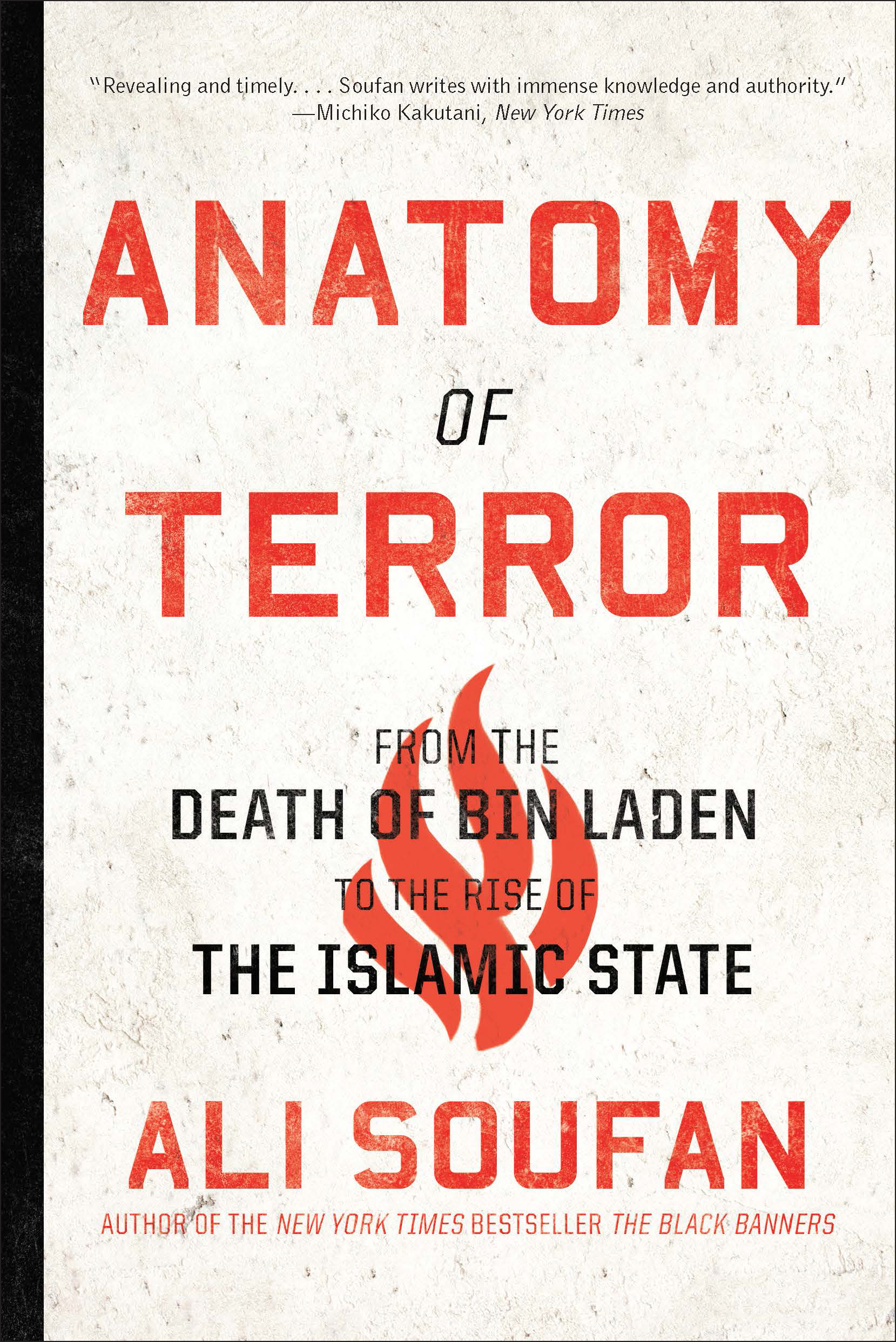
Anatomy of Terror "Anyone who wants to understand the world we live in now should read this book." —Lawrence Wright To eliminate the scourge of terrorism, we must first know who the enemy actually is, and what his motivations are. In Anatomy of Terror, former FBI special agent and New York Times best-selling author Ali Soufan dissects Osama bin Laden’s brand of jihadi terrorism and its major offshoots, revealing how these organizations were formed, how they operate, their strengths, and—crucially—their weaknesses. This riveting account examines the new Islamic radicalism through the stories of its flag-bearers, including a U.S. Air Force colonel who once served Saddam Hussein, a provincial bookworm who declared himself caliph of all Muslims, and bin Laden’s own beloved son Hamza, a prime candidate to lead the organization his late father founded. Anatomy of Terror lays bare the psychology and inner workings of al-Qaeda, the Islamic State, and their spawn, and shows how the spread of terror can be stopped. Winner of the Airey Neave Memorial Book Prize POLITICAL SCIENCE,Terrorism

Black Site A bold account of one of the most controversial and haunting initiatives in American history, Black Site tells the full story of the post-9/11 counterterrorism world at the CIA. When the towers fell on September 11, 2001, nowhere were the reverberations more powerfully felt than at CIA headquarters in Langley, Virginia. Almost overnight, the intelligence organization evolved into a warfighting intelligence service, constructing what was known internally as “the Programâ€: a web of top-secret detention facilities intended to help prevent future attacks on American soil and around the world. With Black Site, former deputy director of the CIA Counterterrorist Center Philip Mudd presents a full, never-before-told story of this now-controversial program, directly addressing how far America went to pursue al-Qa’ida and prevent another catastrophe. Heated debates about torture were later ignited in 2014 after the US Senate published a report of the Program, detailing the CIA’s use of “enhanced interrogation techniques†to draw information from detainees. The report, Mudd posits, did not fully address key questions: How did the officials actually come to their decisions? What happened at the detention facilities—known as “Black Sitesâ€â€”on a day-to-day basis? What did they look like? How were prisoners transported there? And how did the officers feel about what they were doing? Black Site seeks answers to these questions and more, first by examining pre-9/11 Langley, when the CIA was tasked with collecting, disseminating, and analyzing information related to overseas events. Mudd argues that September 12, 2001, marked an operational revolution, as officials suddenly felt the weight of protecting a nation from a second wave of attacks inside the United States. Re-creating the incredibly tense atmosphere of the time, Mudd reveals that many officials felt an unshakable personal responsibility to thwart another attack. Based on interviews from dozens of officials—many of whom have never spoken out before— Black Site illuminates how the Agency quickly stepped into the process of organizing a full-blown interrogation program. Mudd offers a deeper understanding of how the enhanced interrogation techniques were developed and how intelligence professionals prepared to talk to the world’s most hardened terrorists. With careful detail, he takes us through the process of each legally approved technique, including waterboarding. As compelling as it is revelatory, Black Site shows us the tragedy and triumph of the CIA during its most difficult days. POLITICAL SCIENCE,Terrorism

Anti-american Terrorism Volume I examined the policies and actions in the Eisenhower, Kennedy, and Johnson administrations that contributed to the creation of anti-American grievances which in turn fueled the rise of anti-American terrorism overseas and domestically during the Nixon, Ford, and Carter administrations. Volume II chronicles the high-water mark of anti-American terrorism overseas that occurred during the Reagan administration. The litany of terrorist attacks on US targets overseas during this period is well known and unmatched in American history: 1983 suicide attack on US Embassy Beirut, 1983 suicide attack on US Marine Barracks Beirut, 1983 suicide attack on US Embassy Kuwait, 1984 suicide attack on US Embassy Beirut, 1985 assault on the TWA counter at Rome airport, 1985 hijacking of TWA 847, 1986 mid-air bombing of TWA 840, 1988 mid-air bombing of Pan Am 103, and the 1982-1988 kidnappings of 18 Americans in Lebanon. This wave of anti-American terrorist attacks demanded an appropriate response. The Reagan administration proceeded to construct the most ambitious and costly counter-terrorism program in the pre-9/11 era. Although the terrorist threat was perceived to be in decline during the George H W Bush administration, it still had to deal with the potential terrorist threat emanating from the first Gulf War in 1990-1991, two assassination attempts on the president, and the ramifications of the Pan Am 103 bombing. POLITICAL SCIENCE,Terrorism
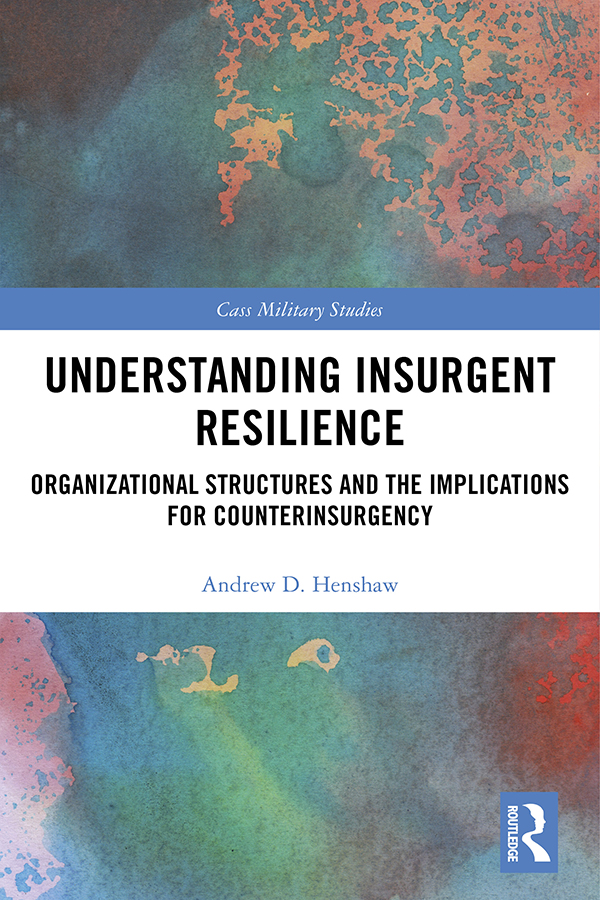
Understanding Insurgent Resilience This book examines terrorist and insurgent organisations and seeks to understand how such groups persist for so long, while introducing a new strategic doctrine for countering these organisations. The work discusses whether familial or meritocratic insurgencies are more resilient to counterinsurgency pressures. It argues that it is not the type of organization that determines resilience, but rather the efficiency functions of social capital and trust, which have different natures and forms, within them. It finds that while familial insurgencies can challenge incumbents from the start, they weaken over time, whereas meritocracies will generally strengthen. The book examines four of the most enduring and lethal insurgent organizations: the Haqqani Network in Afghanistan, Lashkar-e-Taiba in Pakistan, Jemaah Islamiyah in Indonesia, and the Abu Sayyaf in the Philippines. The author breaks down each group into its formative strengths and vulnerabilities and presents a bespoke model of strategic counterintelligence that can be used to manipulate, degrade and destroy each organization. This book will be of much interest to students of counterinsurgency, terrorism, intelligence, security and defence studies in general. POLITICAL SCIENCE,Terrorism

The 7/7 London Underground Bombing, Not So Homegrown An analysis of the suicide attacks against London transportation targets that killed 56 people and injured hundreds, by the author of Inside Terrorism. It was among the most important operations directed by core al Qaeda leaders in years following the events of September 11, 2001. Initially, the incident was dismissed by the authorities, pundits, and the media as the work of amateur terrorists—untrained, self-selected and self-radicalized, “bunches of guys†acting on their own with no links to any terrorist organization. Evidence presented here, however, reveals a clear link between the bombers and the highest levels of the al Qaeda senior command, then based in the lawless border area separating Afghanistan and Pakistan. Written by the author of Inside Terrorism, this chapter is part of the Columbia Studies series that examines major terrorist acts and campaigns undertaken in the decade following 9/11. POLITICAL SCIENCE,Terrorism
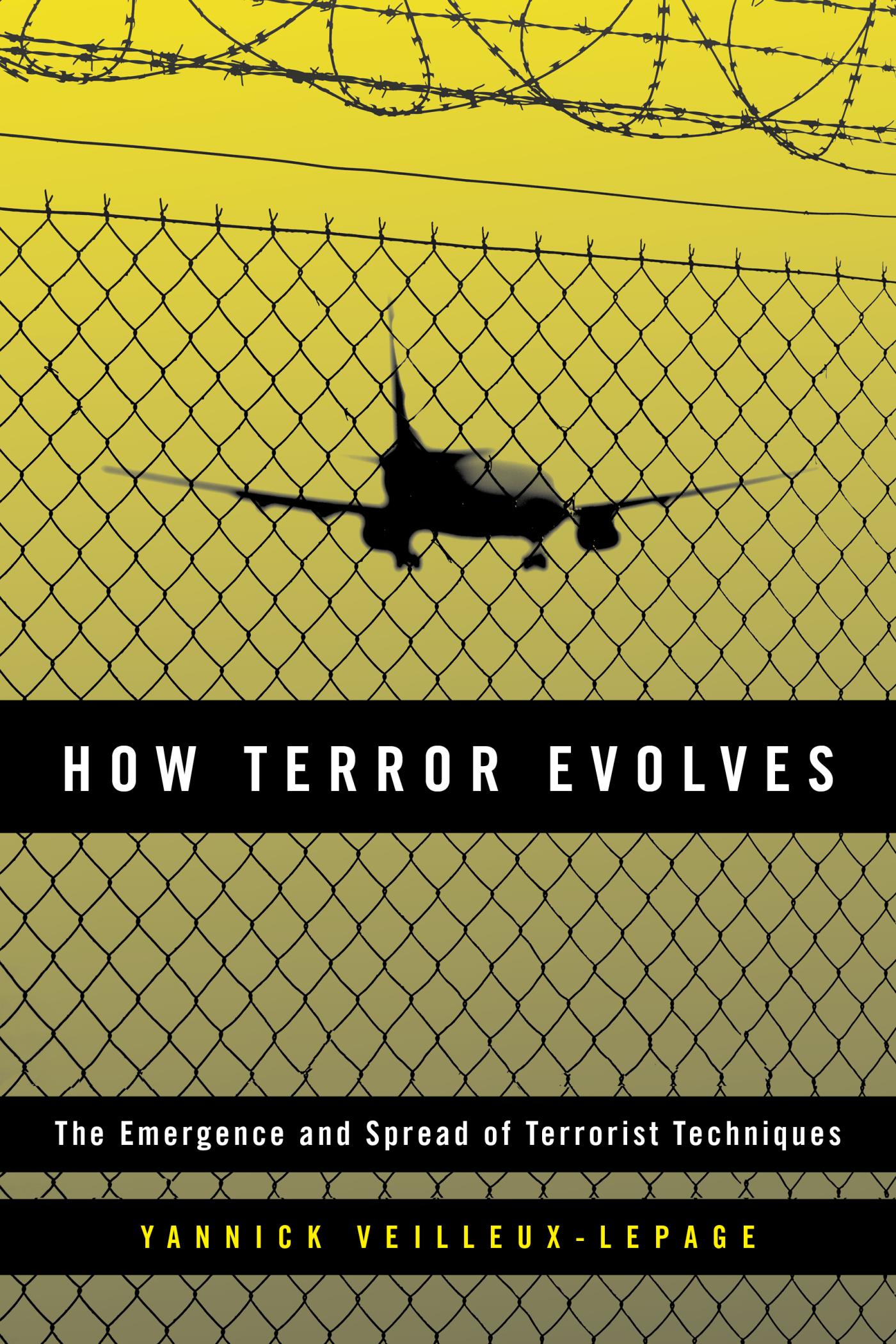
How Terror Evolves This book contextualizes the use of terror as part of wider movements of political contention, demonstrating that terroristic innovation occurs as part of wider historical processes rather than in a vacuum. POLITICAL SCIENCE,Terrorism

Utopia 'It remains astonishingly radical ... one of Utopia's most striking aspects is its contemporaniety' Terry Eagleton In Utopia, Thomas More gives us a traveller's account of a newly-discovered island where the inhabitants enjoy a social order based on natural reason and justice, and human fulfilment is open to all. As the traveller describes the island, a bitter contrast is drawn between this rational society and the practices of Europe. How can the philosopher reform his society? In his discussion, More takes up a question first raised by Plato and which is still a challenge in the contemporary world. In the history of political thought few works have been more influential than Utopia, and few more misunderstood. Translated and introduced by Dominic Baker-Smith POLITICAL SCIENCE,Utopias
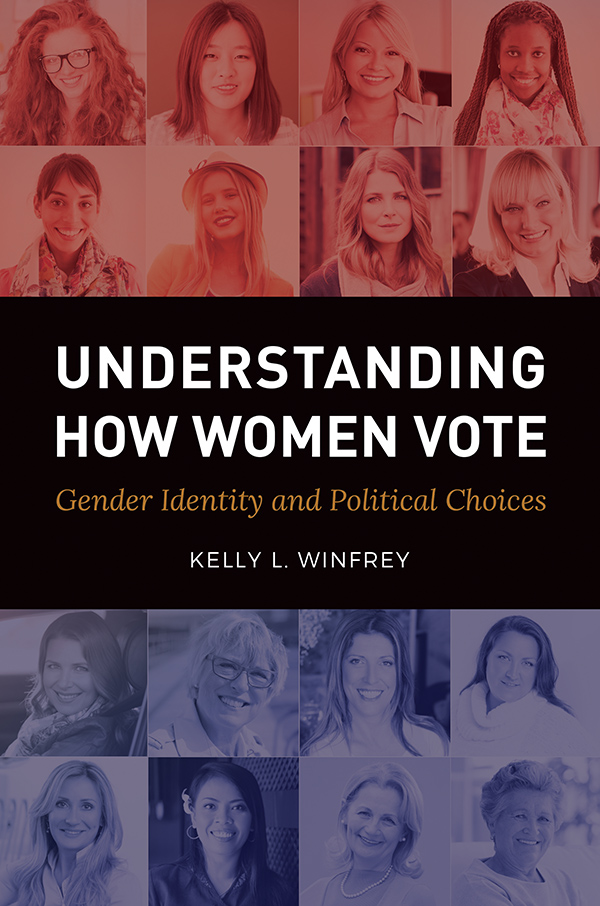
Understanding How Women Vote Research shows that voting women are distinctly different from voting men. Because the women's vote has been important in nearly every election since the 1980s, it's critical to understand why this gender gap exists and what it means for American politics. This thought-provoking study offers an accessible introduction to research on gender and elections while providing new insights into women's voting behaviors. Based on original research with women voters of varying ages around the United States from 2008 to the present, the book delves into differences between voting women and men—and indeed among women themselves. The gender gap, the author argues, exists because women's social identity is tied to their group memberships and gender-role beliefs. Thus, rather than grouping all women into one voting bloc, the book examines how gender identity influences various sub-groups of women. It begins with a discussion of the gender gap in voting preferences throughout history, then goes on to explore the roles of feminism and women's connectedness to their gender group as a primary cause of the gender gap in voting. The remaining chapters discuss how these factors influence women's political engagement, policy positions, and candidate preferences. POLITICAL SCIENCE,Women in Politics

Be The Change BE THE CHANGE is an essential handbook for the modern activist, whether your campaign is big or small, local or global, or somewhere in between. 'Gina Martin's powerful campaigning and vital activism changed the law, making our country safer for women and girls. This book tells us how she did it - and how you can too' Sadiq Khan, Mayor of London In June 2017, a man took a photo up Gina Martin's skirt at a music festival. The police told her that this was not a sexual offence; the man would not be charged. The law had let Gina down, and her first reaction was resignation. It's too big, too scary, too complicated for someone like me to challenge this. But something inside her had snapped. Gina was tired of accepting sexual harassment as a fact of life. Eighteen months later, she had changed the law and made upskirting a criminal offence. Now, Gina wants to empower you with the tools and courage to challenge injustice and fight for change, whether it's in your school, workplace or community, or even on a global scale. In BE THE CHANGE you will learn: What activism really is and why it's so important How to use the internet to fight for what you believe in How to pick the cause you truly care about And how to do the hardest thing in activism: get started Be the Change also includes plenty of practical advice like how to write a press release, set up an e-petition, find pro-bono legal support and secure media coverage for your campaign. Praise for Gina Martin: 'Gina is a total inspiration - an example of how one person CAN change things'EMMA GANNON, Sunday Times bestselling author of The Multi-Hyphen Method 'Gina Martin is a sensation. A one-woman whirlwind whose campaigning skills and passion for justice achieved vital legal change which the staid political establishment would otherwise have left unremedied'THE SECRET BARRISTER, Sunday Times bestselling author of The Secret Barrister: Stories of the Law and How It's Broken POLITICAL SCIENCE,Women in Politics
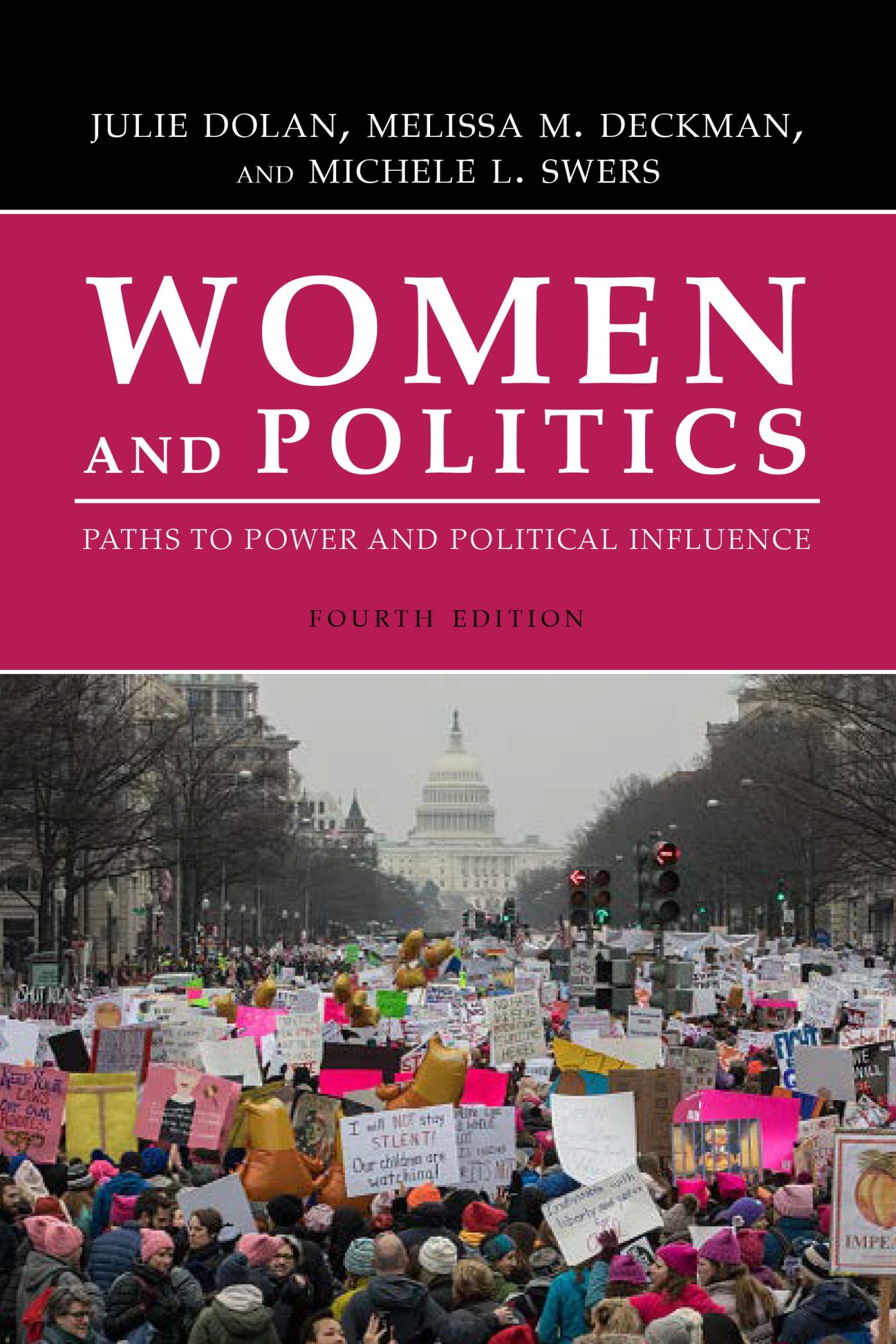
Women and Politics This book examines the role of women in politics from the early women’s movement to the female politicians in power today. Engaging profiles of the key players who have shaped our political system are interwoven with an analysis of the most recent election data to provide a comprehensive and unbiased introduction to the study of women and politics. POLITICAL SCIENCE,Women in Politics

The Nancy Pelosi Way “Her story is unique, but I hope the lessons are universal.â€â€”Christine Pelosi Understand and apply the wisdom of Madam Speaker Nancy Pelosi—through the eyes of someone who knows her best. In this personal and important book Christine Pelosi takes a close look at how her mother went from homemaker to Speaker of the House of Representatives and became the most powerful female politician in America. Her book addresses Speaker Pelosi’s role in current events, and offers advice on politics, family, and friendship gleaned from her mother’s life. From her childhood in Baltimore to her hands-on motherhood in San Francisco to her national leadership, this book demonstrates how a mother of five and grandmother of nine achieved her success. Chapters include: Know Your Power Proper Preparation Prevents Poor Performance Know Your Authentic Self Claim Your Seat at the Table Build Strategic Alliances Don’t Agonize, Organize And more. In 2007, Nancy Pelosi became the highest-ranking elected female government official in US history when she started her tenure as Speaker of the House of Representatives. In January 2019, she began her third term as Speaker during a tumultuous time in American political history. Having represented San Francisco for thirty-two years, she has become well-known for her work to expand health care, lift up workers, protect the environment, promote human rights, and make progress for the American people regardless of the president in the White House or the party controlling Congress. This book serves as the perfect guide for anyone looking to enter public service or prosper as a leader in their own field. POLITICAL SCIENCE,Women in Politics

The Hunting of Hillary "About that vast, right-wing conspiracy...Michael D'Antonio found the receipts."- HILLARY CLINTON The Hunting of Hillary traces how an entire industry of hate, lies, and fear was created to persecute Hillary Clinton for decades and profit from it. In The Hunting of Hillary, Pulitzer prize winning political reporter Michael D’Antonio details the years of lies and insults heaped upon Hillary Clinton as she pursued a life devoted to politics and policy. The worst took the form of sexism and misogyny, much of it barely disguised. A pioneer for women, Clinton was burdened in ways no man ever was. Defined by a right-wing conspiracy, she couldn’t declare what was happening lest she be cast as weak and whiny. Nevertheless, she persisted and wouldn't let them define her. As The Hunting of Hillary makes clear, her achievements have been all the more remarkable for the unique opposition she encountered. The 2016 presidential election can only be understood in the context of the primal and primitive response of those who just couldn’t imagine that a woman might lead. For those who seek to understand the experience of the most accomplished woman in American politics, The Hunting of Hillary offers insight. For those who recognized what happened to her, it offers affirmation. And for those who hope to carry Clinton’s work into the future, it offers inspiration and instruction. POLITICAL SCIENCE,Women in Politics

The Mind of a Conservative Woman Reject our society's liberal bias against conservative women and learn how traditional principles will secure a better future for us all with this inspiring guide from a political powerhouse. The Mind of a Conservative Woman challenges women to improve their place in life and open doors for themselves and the next generation through the courage of their convictions. Senator Blackburn expounds upon why beliefs labeled as "traditional" have common ground and can improve all of society, such as: Protecting the next generation, the family, and the freedom of faith and values, Supporting a free market that rewards women who apply their talents and rise to great heights, Respecting the institutions in our nation to make change from the inside, Securing an effective government that will not overreach, and Honoring and respecting those who hold differing opinions. Though it is politically liberal women who receive the attention of left-leaning media and universities, it is conservatism that guarantees what most women hold dear. Blackburn addresses the frustrations of working women and the false perceptions of women presented by the media in general. Her maxim "Leave Things in Better Shape Than You Found Them" will challenge you to improve your place in life and create opportunities you never dreamed possible for yourself and those around you. POLITICAL SCIENCE,Women in Politics

Speaking for Myself The Instant New York Times, Publishers Weekly, Wall Street Journal, and USA Today Bestseller A candid, riveting account of the Trump White House, on the front lines and behind the scenes. Sarah Huckabee Sanders served as White House Press Secretary for President Donald J. Trump from 2017 to 2019. A trusted confidante of the President, Sanders advised him on everything from press and communications strategy to personnel and policy. She was at the President’s side for two and a half years, battling with the media, working with lawmakers and CEOs, and accompanying the President on every international trip, including dozens of meetings with foreign leaders—all while unfailingly exhibiting grace under pressure. Upon her departure from the administration, President Trump described Sarah as “irreplaceable,†a “warrior†and “very special person with extraordinary talents, who has done an incredible job.†Now, in Speaking for Myself, Sarah Huckabee Sanders describes what it was like on the front lines and inside the White House, discussing her faith, the challenges of being a working mother at the highest level of American politics, her relationship with the press, and her unique role in the historic fight raging between the Trump administration and its critics for the future of our country. This frank, revealing, and engaging memoir will offer a truly unique perspective on the most important issues and events of the era, and unprecedented access to both public and behind-the-scenes conversations within the Trump White House. POLITICAL SCIENCE,Women in Politics

Decisions and Dissents of Justice Ruth Bader Ginsburg National Indie Bestseller The trailblazing Supreme Court Justice Ruth Bader Ginsburg in her own words. Her most essential writings on gender equality and women's rights, reproductive health care, and voting and civil rights, now available in a short, accessible volume as part of the new Penguin Liberty series. A Penguin Classic Penguin Liberty is a newly curated series of classic historical, political and legal classic texts relevant to constitutional rights. This collection includes key concurrences, dissents, and selected writings by Justice Ginsburg that address gender equality and women's rights, reproductive health care, and voting and civil rights. The volume includes Justice Ginsburg's landmark Supreme Court opinions for cases including Bush v. Gore (2000), Lily Ledbetter v. Goodyear Tire & Rubber Company (2007), Shelby County v. Holder (2013), Burwell v. Hobby Lobby (2014), and more. Each Penguin Liberty volume will feature a series introduction and volume introduction by series editor Corey Brettschneider. POLITICAL SCIENCE,Women in Politics
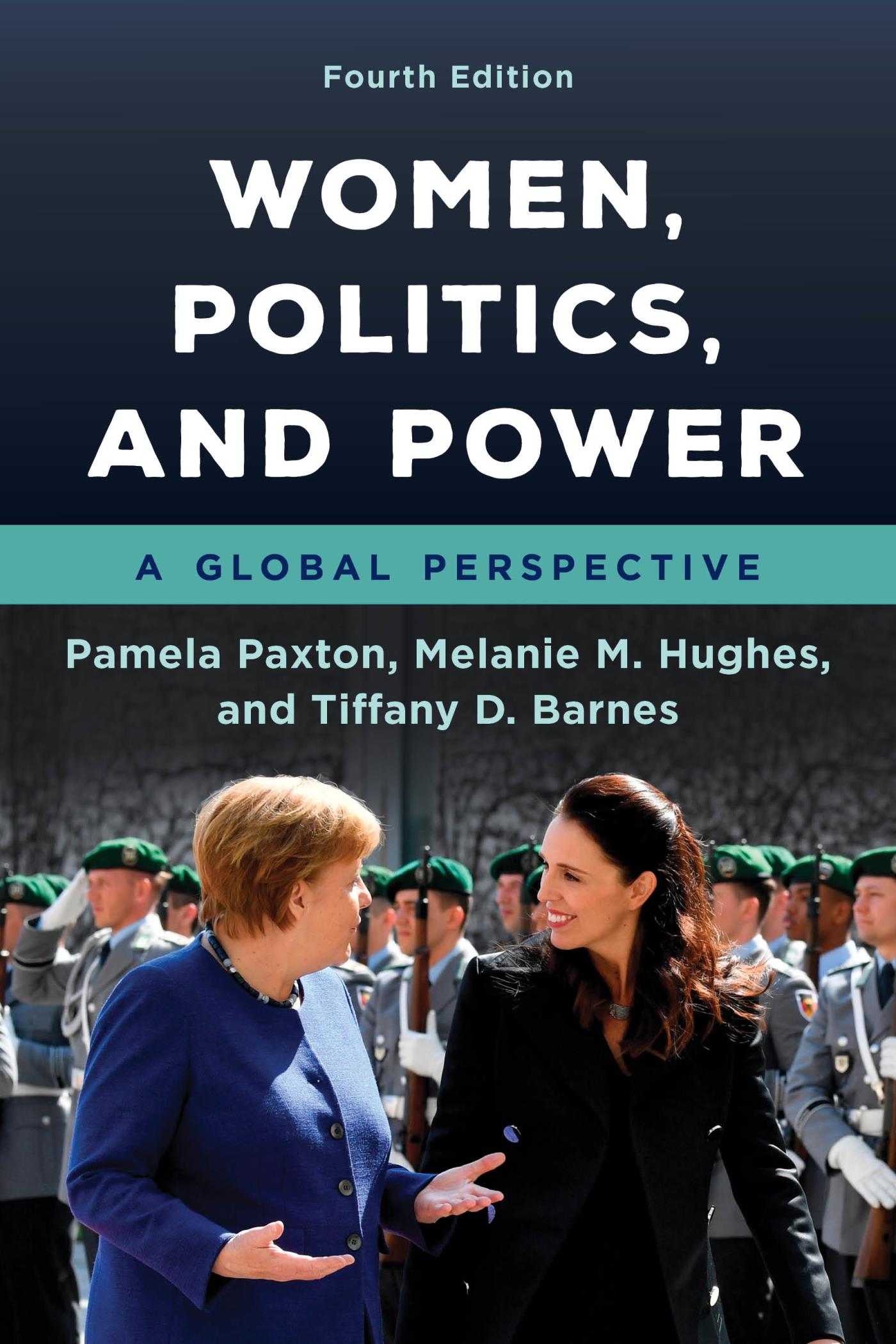
Women, Politics, and Power This book provides a clear, detailed introduction to women’s political participation and representation across a wide range of countries and regions. Through broad statistical overviews and detailed case-study accounts, the authors document both historical trends and the contemporary state of women’s political strength. POLITICAL SCIENCE,Women in Politics

Quotable Elizabeth Warren US Senator Elizabeth Warren has long been an original thinker and a powerful voice for the common man. Having worked her first job at the age of nine and witnessed first-hand the economic struggles of the American middle class, Warren never hesitates to tell the truth about the US economy. She has been a strong advocate for consumer protection; her work has led to the creation of the US Consumer Financial Protection Bureau. Discover in her own words the woman who has been called a New Sheriff of Wall Street†by TIME magazine, and the plainspoken voice of people getting crushed by so many predatory lenders and under regulated banks†by the Boston Globe. There is nobody in this country who got rich on their own. Nobody. . . . Part of the underlying social contract is you take a hunk of that and pay forward for the next kid who comes along.†Hardworking men and women who are busting their tails in full-time jobs shouldn’t be left in poverty.†If you’re caught with an ounce of cocaine, the chances are good you’re going to jail. . . Evidently, if you launder nearly a billion dollars for drug cartels and violate our international sanctions, your company pays a fine and you go home and sleep in your own bed at night.†POLITICAL SCIENCE,Women in Politics

The Shadow of the Sun In 1957, Ryszard Kapuscinski arrived in Africa to witness the beginning of the end of colonial rule as the first African correspondent of Poland's state newspaper. From the early days of independence in Ghana to the ongoing ethnic genocide in Rwanda, Kapuscinski has crisscrossed vast distances pursuing the swift, and often violent, events that followed liberation. Kapuscinski hitchhikes with caravans, wanders the Sahara with nomads, and lives in the poverty-stricken slums of Nigeria. He wrestles a king cobra to the death and suffers through a bout of malaria. What emerges is an extraordinary depiction of Africa--not as a group of nations or geographic locations--but as a vibrant and frequently joyous montage of peoples, cultures, and encounters. Kapuscinski's trenchant observations, wry analysis and overwhelming humanity paint a remarkable portrait of the continent and its people. His unorthodox approach and profound respect for the people he meets challenge conventional understandings of the modern problems faced by Africa at the dawn of the twenty-first century. POLITICAL SCIENCE,World,African
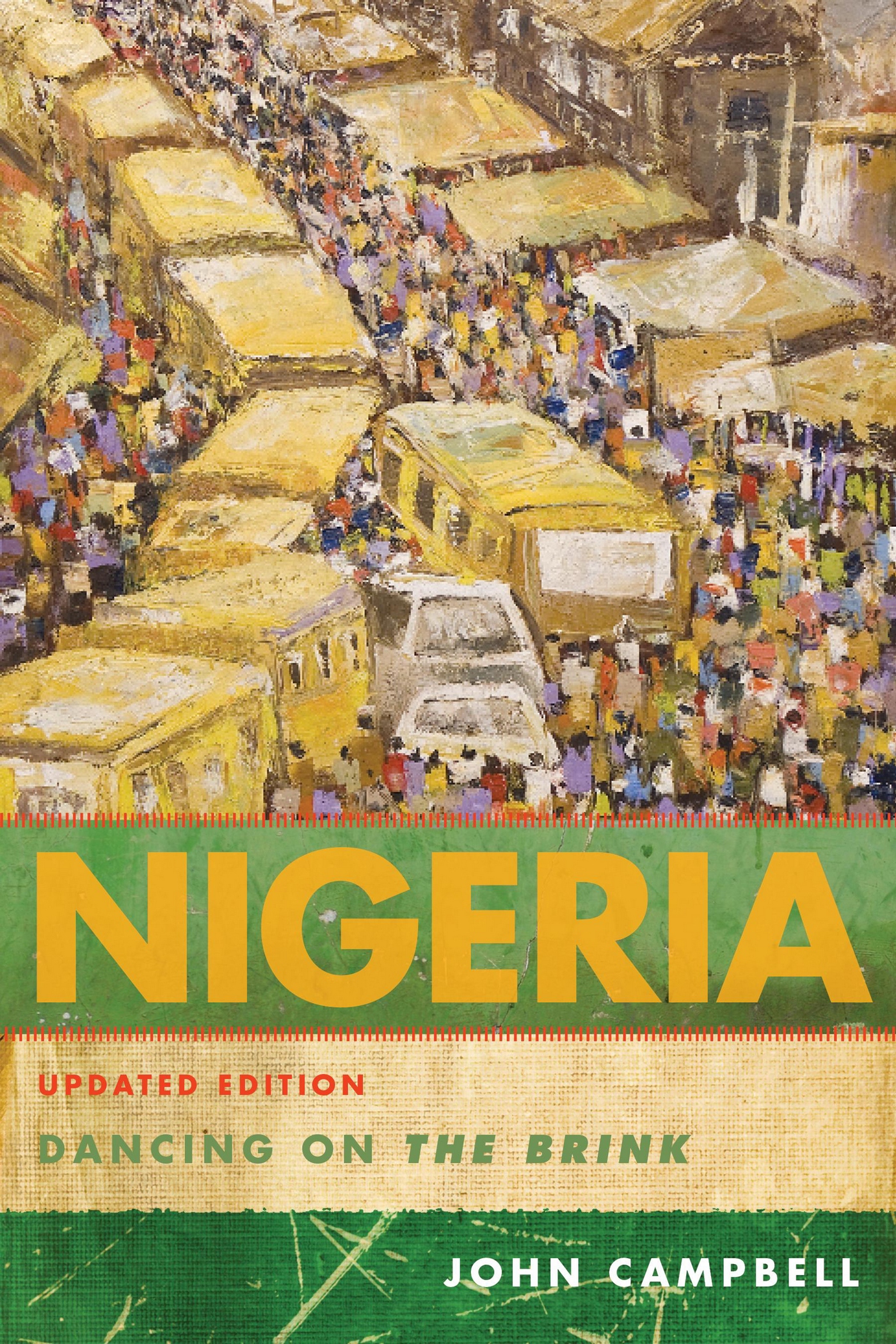
Nigeria In this thoroughly updated edition, John Campbell explores Nigeria’s post-colonial history and presents a nuanced explanation of the events and conditions that have carried this complex, dynamic, and very troubled giant to the brink. Central to his analysis are the oil wealth, endemic corruption, elite competition, and radical Islamic insurrection that have undermined Nigeria’s nascent democratic institutions and alienated an increasingly impoverished population. Campbell provides concrete policy options that would not only allow the United States to help Nigeria avoid state failure but also to play a positive role in Nigeria’s political, social, and economic development. POLITICAL SCIENCE,World,African
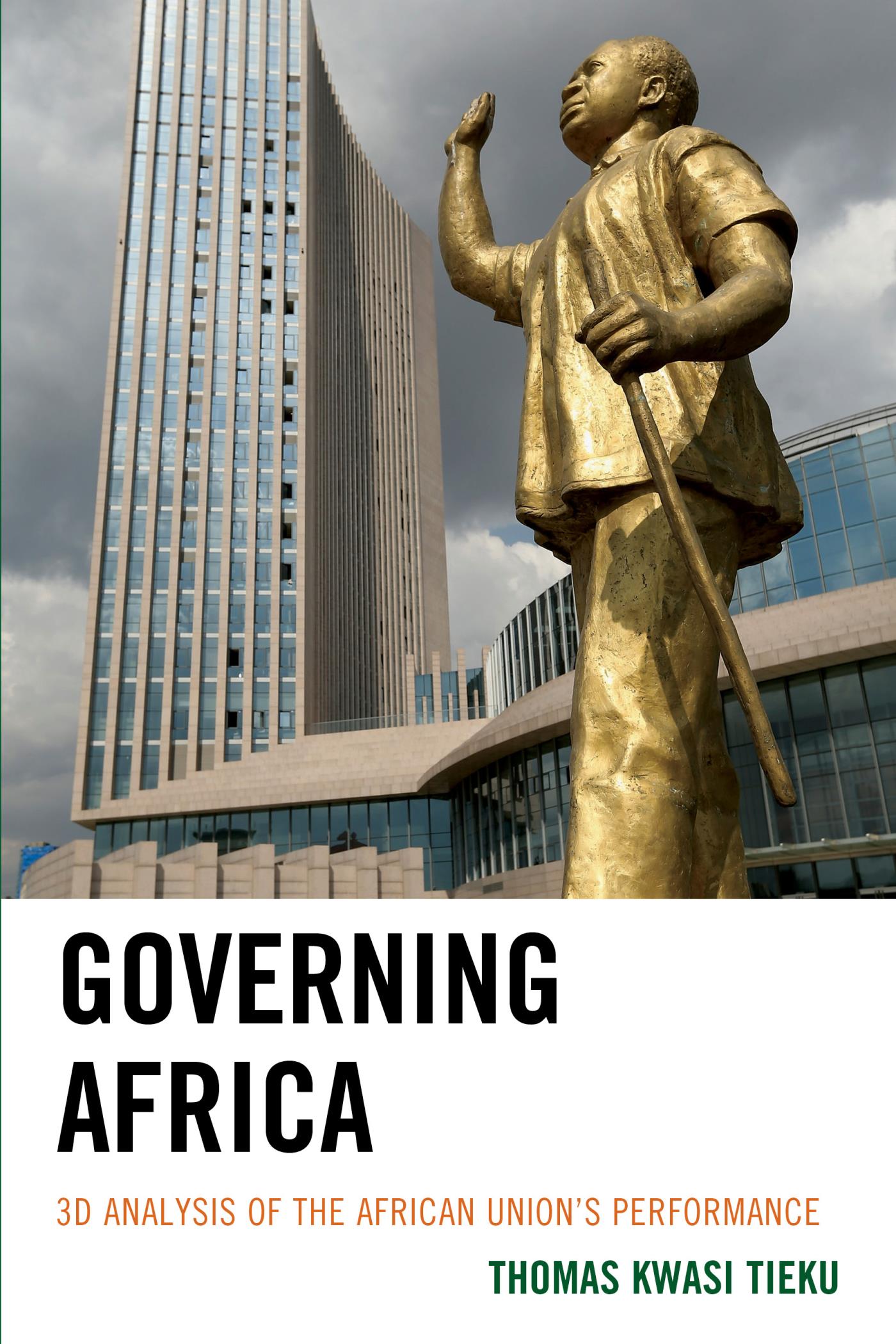
Governing Africa The book examines the AU's performance, role, and the innovative and homegrown solutions it has developed. POLITICAL SCIENCE,World,African
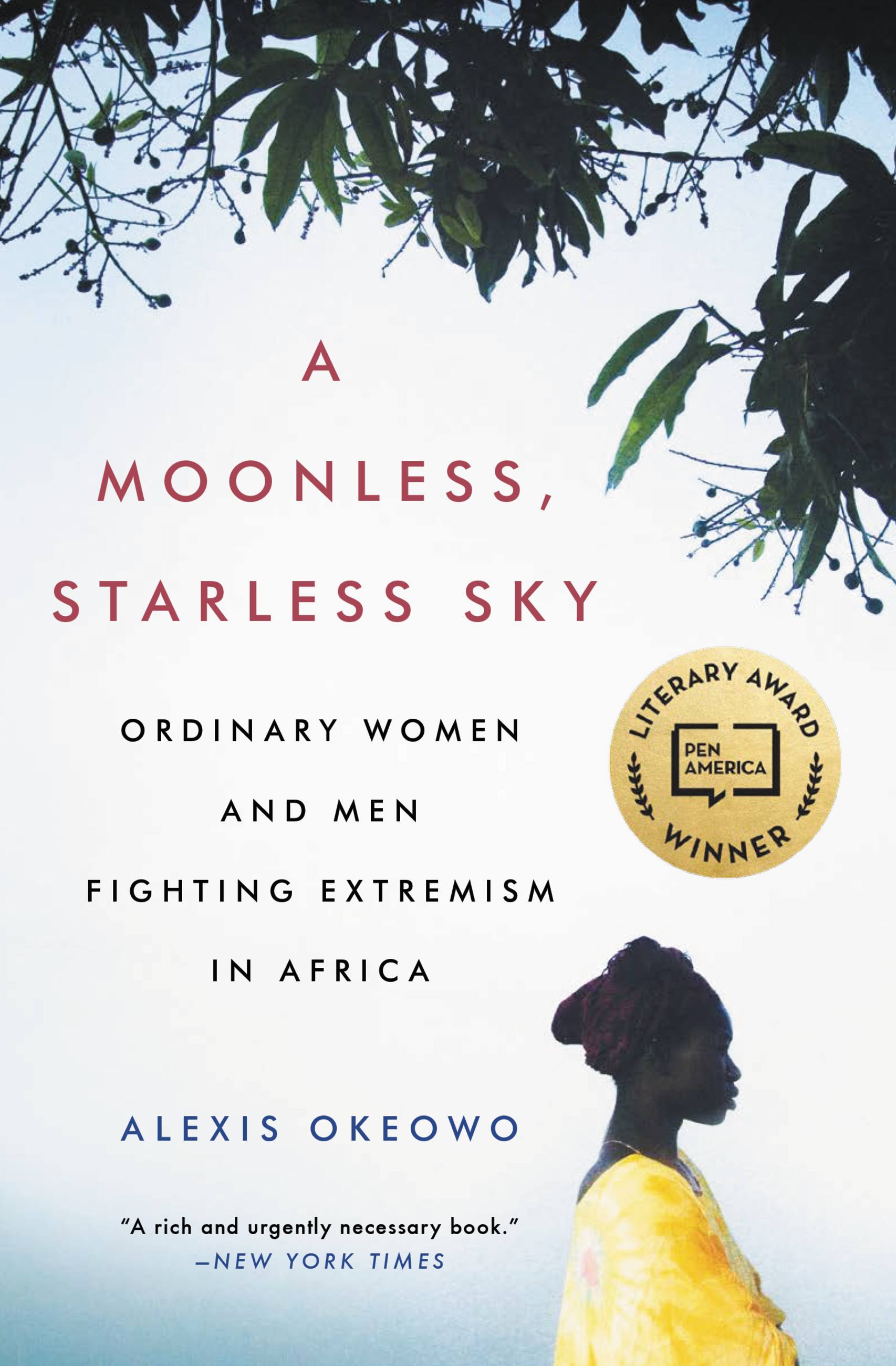
A Moonless, Starless Sky WINNER OF THE 2018 PEN OPEN BOOK AWARD "A rich and urgently necessary book" (New York Times Book Review), A Moonless, Starless Sky is a masterful, humane work of journalism by Alexis Okeowo--a vivid narrative of Africans who are courageously resisting their continent's wave of fundamentalism. In A Moonless, Starless Sky Okeowo weaves together four narratives that form a powerful tapestry of modern Africa: a young couple, kidnap victims of Joseph Kony's LRA; a Mauritanian waging a lonely campaign against modern-day slavery; a women's basketball team flourishing amid war-torn Somalia; and a vigilante who takes up arms against the extremist group Boko Haram. This debut book by one of America's most acclaimed young journalists illuminates the inner lives of ordinary people doing the extraordinary--lives that are too often hidden, underreported, or ignored by the rest of the world. POLITICAL SCIENCE,World,African

The Burning Shores A riveting, beautifully crafted account of Libya after Qadhafi. The death of Colonel Muammar Qadhafi freed Libya from forty-two years of despotic rule, raising hopes for a new era. But in the aftermath, the country descended into bitter rivalries and civil war, paving the way for the Islamic State and a catastrophic migrant crisis. In a fast-paced narrative that blends frontline reporting, analysis, and history, Frederic Wehrey tells the story of what went wrong. An Arabic-speaking Middle East scholar, Wehrey interviewed the key actors in Libya and paints vivid portraits of lives upended by a country in turmoil: the once-hopeful activists murdered or exiled, revolutionaries transformed into militia bosses or jihadist recruits, an aging general who promises salvation from the chaos in exchange for a return to the old authoritarianism. He traveled where few Westerners have gone, from the shattered city of Benghazi, birthplace of the revolution, to the lawless Sahara, to the coastal stronghold of the Islamic State in Qadhafi’s hometown of Sirt. He chronicles the American and international missteps after the dictator’s death that hastened the country’s unraveling. Written with bravura, based on daring reportage, and informed by deep knowledge, The Burning Shores is the definitive account of Libya’s fall. POLITICAL SCIENCE,World,African

The African Experience This masterpiece of scholarship and compression, the second edition of The African Experience, covers the entire span of human history across the African continent, from the earliest emergence of hominids in eastern and southern Africa up to the present day. Drawing on more than forty years of teaching and research, Professor Oliver arranges the book thematically, beginning with the human colonization of the different regions of Africa, the origins of food production, and the formation of African languages.The achievements of Ancient Egypt are placed in context with the developments in the rest of the continent, and the spread of Judaism, Christianity, and Islam - "peoples of the book." The tradition of urban settlement is traced, especially in western Africa, as well as the emergence of large and complex societies formed by the interaction of pastoralists and cultivators in eastern and southern Africa.The extent and nature of slavery in Africa is fully discussed, together with the external slave trade and the caravan trade in precolonial times. This leads to an analysis of the strengths and weaknesses of African political systems and why, from the early nineteenth century onwards, these systems were unable to withstand political pressure from abroad and the ensuing colonization. The colonial partition of Africa saw the rapid amalgamation of small units, through which considerable modernization was achieved at the expense of the indigenous structures and through the exploitation of the African peoples. Later chapters describe the birth of modern African nation-states, at a time of widespread belief in state planning - now being questioned as the political elites of black Africa begin to review their single-party systems. This new edition sees a number of revisions, including a new chapter on the 1990s, when the end of the Cold War left Africa free at last to try to solve its own problems. POLITICAL SCIENCE,World,African
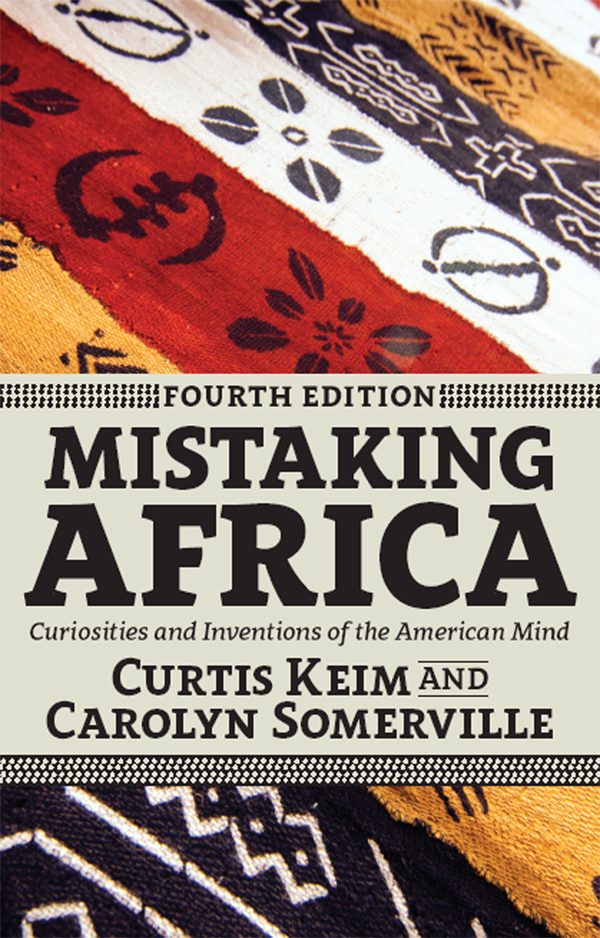
Mistaking Africa For many Americans the mention of Africa immediately conjures up images of safaris, ferocious animals, strangely dressed "tribesmen," and impenetrable jungles. Although the occasional newspaper headline mentions authoritarian rule, corruption, genocide, devastating illnesses, or civil war in Africa, the collective American consciousness still carries strong mental images of Africa that are reflected in advertising, movies, amusement parks, cartoons, and many other corners of society. Few think to question these perceptions or how they came to be so deeply lodged in American minds. Mistaking Africa looks at the historical evolution of this mind-set and examines the role that popular media plays in its creation. The authors address the most prevalent myths and preconceptions and demonstrate how these prevent a true understanding of the enormously diverse peoples and cultures of Africa.Updated throughout, the fourth edition covers the entire continent (North and sub-Saharan Africa) and provides new analysis of topics such as social media and the Internet, the Ebola crisis, celebrity aid, and the Arab Spring. Mistaking Africa is an important book for African studies courses and for anyone interested in unravelling American misperceptions about the continent. POLITICAL SCIENCE,World,African
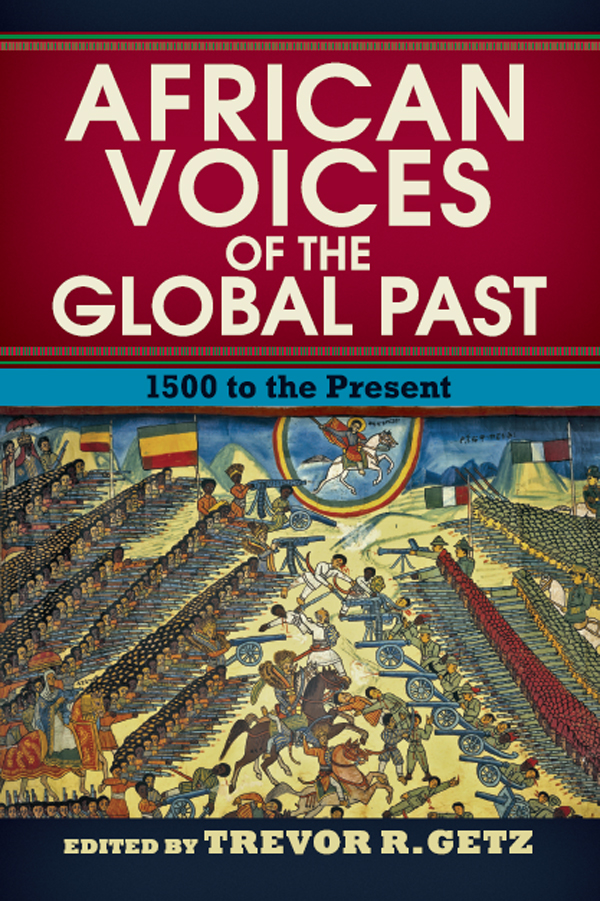
African Voices of the Global Past This book focuses on retelling many of the important episodes in the global past (c.1500–present) from African points of view. It discusses the events and trends of global significance: the Atlantic slave system, the industrial revolution, World Wars I and II, and decolonization. POLITICAL SCIENCE,World,African

Africa in World Politics The sixth edition of Africa in World Politics focuses on challenges African states face in constructing viable political economies in contexts both of familiar domestic challenges and an unprecedented mix of engagements, opportunities, and threats emanating from a turbulent and rapidly changing international order. This text, including new chapters on Nigeria and the influence of party politics on economic development, remains an invaluable resource for students of African politics seeking to navigate the continent's complex political and economic landscapes. Revised chapters consider both the extent and the limits of continued healthy growth rates in many countries; the impacts of investments by China and other BRICS countries; plateaus and some reversals in progress on human rights and democratization; dimensions of chronic state weakness deepened by insurgencies, including some that are connected to Al Qaeda and the Islamic State; and peacebuilding efforts struggling to uphold responsible sovereignty in the Sudans, the Great Lakes region, and elsewhere. POLITICAL SCIENCE,World,African
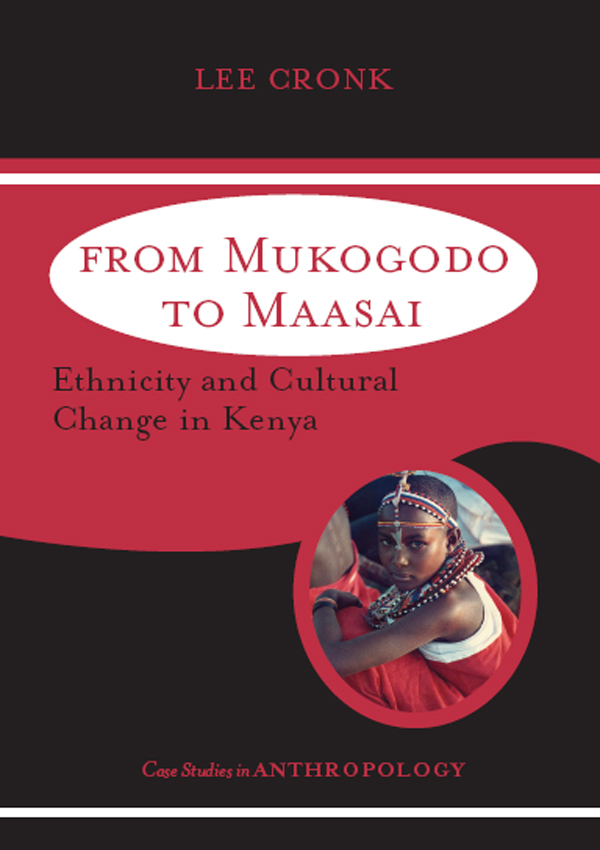
From Mukogodo to Maasai This book focuses on the strategic manipulation of ethnic identity by the Mukogodo of Kenya. It is about how Mukogodo people changed their way of life to a radically different one, that is their change as Maasai people, giving them a new way of living, a new language, and a new set of beliefs. POLITICAL SCIENCE,World,African

The Changing Face of Empire The Changing Face of Empire is a devastating anatomy of the U.S. military’s new six-point program for twenty-first-century war. POLITICAL SCIENCE,World,African
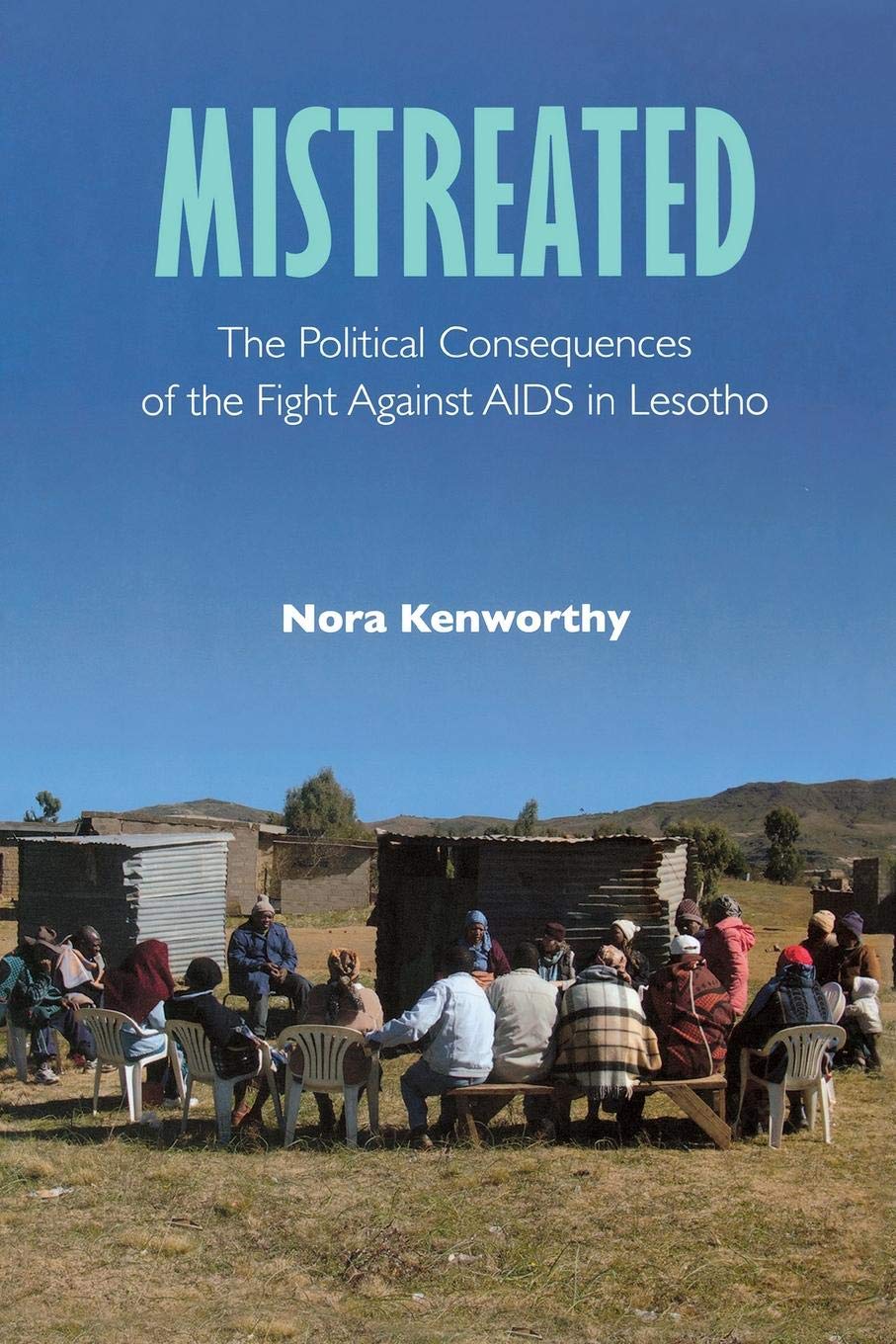
Mistreated A critical ethnography of global health initiatives, showing how, even as they save lives, they can usher in new forms of disenfranchisement for citizens in African states POLITICAL SCIENCE,World,African
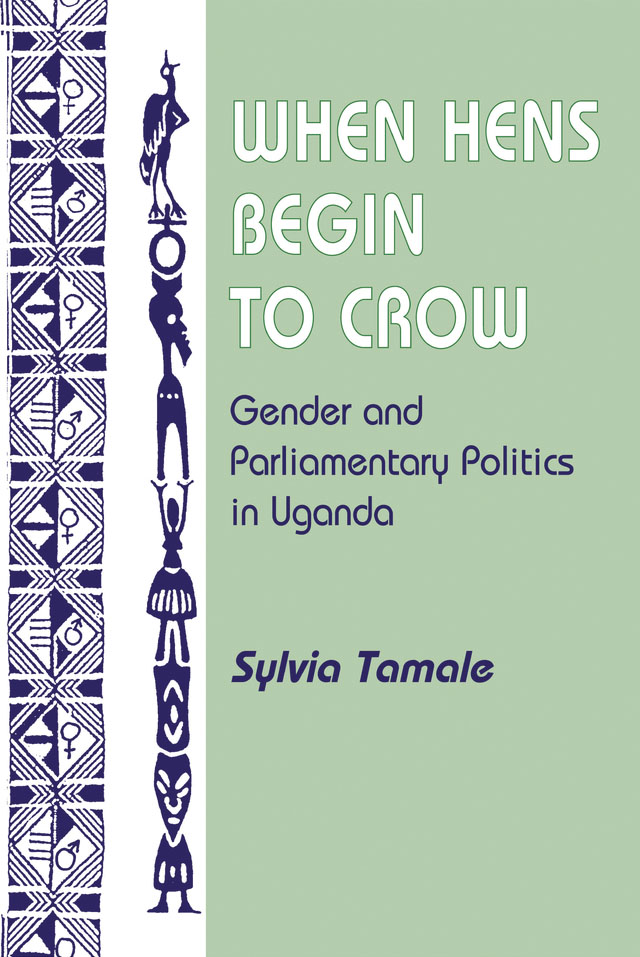
When Hens Begin To Crow Among African countries, Uganda is unique in its affirmative action program for women. In the late 1980s, President Yoweri Museveni announced his belief that Uganda's successful development depended on increased gender equity and backed his opinions by setting several women-centered policies in motion, including a 1989 rule that at least 39 seats in the Ugandan parliament be reserved for women.In this fascinating study, based on in-depth interviews with both male and female parliamentarians, women in nongovernmental organizations, and rural residents of Uganda, Sylvia Tamale explores how women's participation in Ugandan politics has unfolded and what the impact has been for gender equity. The book examines how women have adapted their legislative strategies for empowerment in light of Uganda's patriarchal history and social structure. The author also looks at the consequences and implications of women's parliamentary participation as a result of affirmative action handed down by the president, rather than pushed up from a grassroots movement.Although focusing on Uganda, Tamale's study is relevant to other African and non-African countries grappling with the twin challenges of democracy and development. POLITICAL SCIENCE,World,African
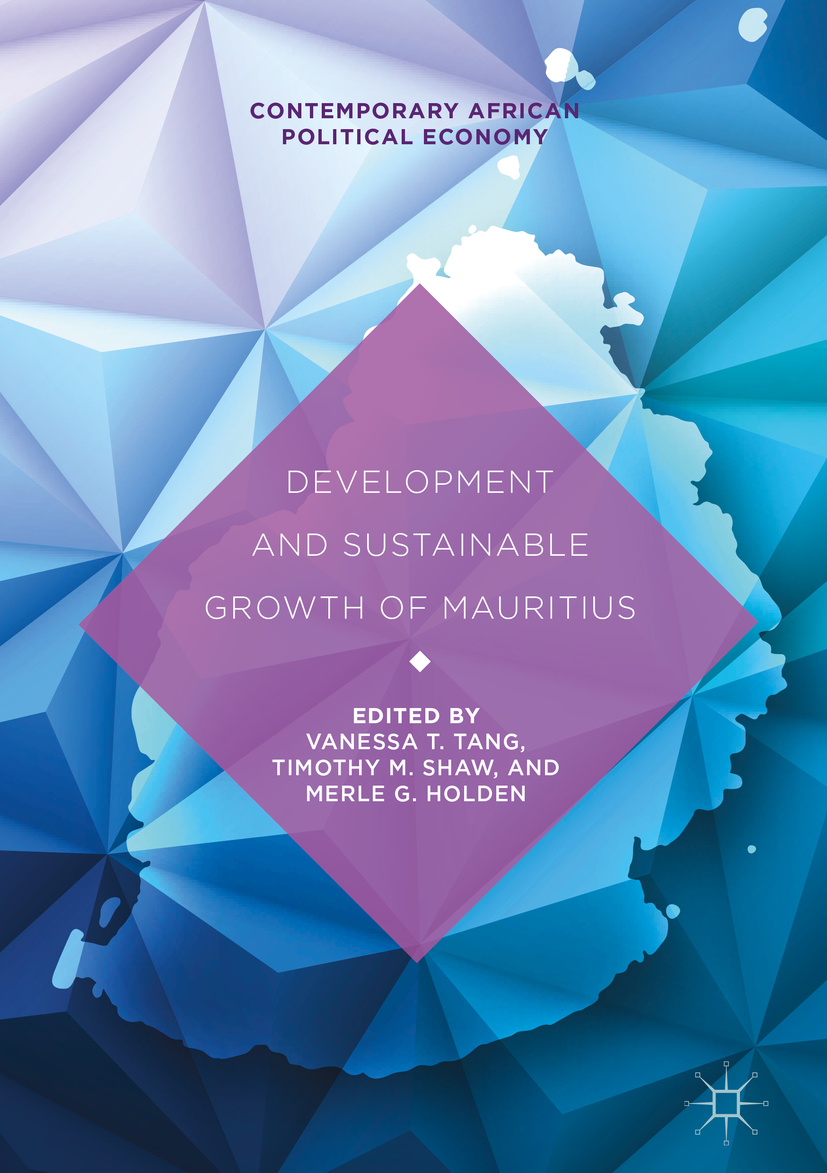
Development and Sustainable Growth of Mauritius This edited volume analyzes the Mauritius economy and highlights what conditions and policies have contributed to the development of the country. The project gives a historical and economic analysis of Mauritius and provides comparative approaches looking at other developing states in Africa and Asia. This book is intended for a broad audience, consisting of not only economists with quantitative expertise but also other social scientists, policymakers and scholars interested in the intellectually fascinating exploration of Mauritius’s rapid rise and sustained growth performance. POLITICAL SCIENCE,World,African

The Islamist Challenge and Africa The Islamist Challenge and Africa examines Islamist militancy among Africans historically and at present, a topic largely ignored in the United States. It examines Islamist militancy’s longstanding presence in Africa and its diaspora, Islamist militancy’s distinct ideological features among Africans, and ways to minimize its violence. POLITICAL SCIENCE,World,African
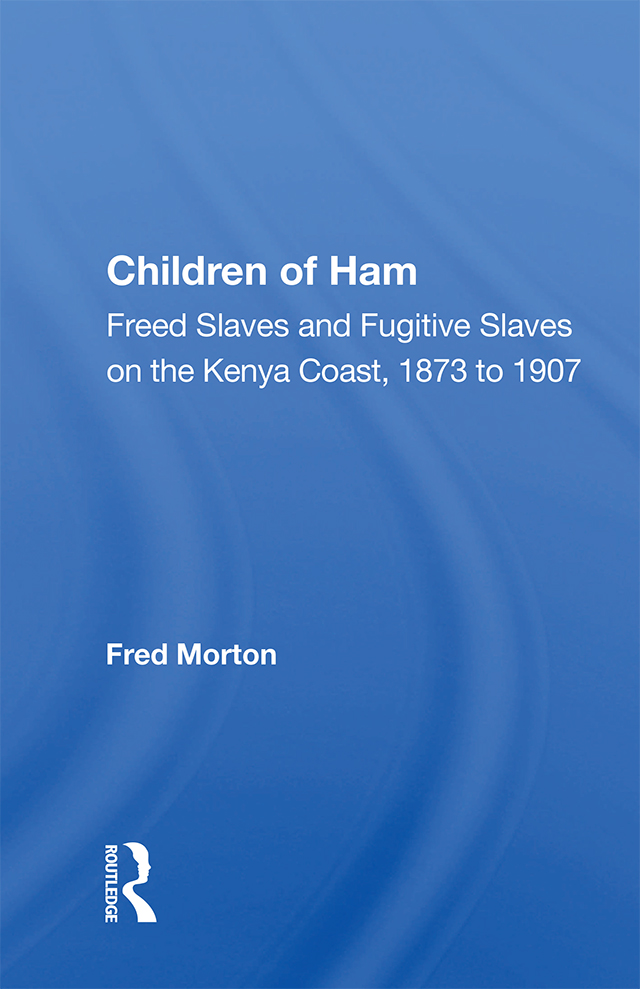
Children Of Ham Children of Ham: Freed Slaves and Fugitives Slaves on the Kenya Coast,I 873 to 1907 is a chronological account of the repeated bids for freedom made by slaves and ex-slaves on the Kenya coast and of the obstacles placed in their way by the British, the Busaidi Arabs, and the peoples of the coast. Efforts to escape slavery are as old as slavery itself on the Kenya coast, but the principal story begins in 1873, when Britain pressured the sultan of Zanzibar to abolish the ocean-going slave trade. Thereafter, political and military conflict intensified on the coast, while opportunities for slaves to escape increased accordingly. This period, ending roughly with the abolition of the legal status of slavery in 1907, corresponds to the imperial scramble from its earliest stages to the effective establishment of European rule. POLITICAL SCIENCE,World,African

Africa's International Relations The author presents a journey through African and Western history, culture and politics. By essaying Africa's international relations, Mazrui returns to an important truth: the power of race and culture in Africa's relations with the West. Discussing African political formation, his overriding theme, not unpredictably, is assimilation - of the enti POLITICAL SCIENCE,World,African
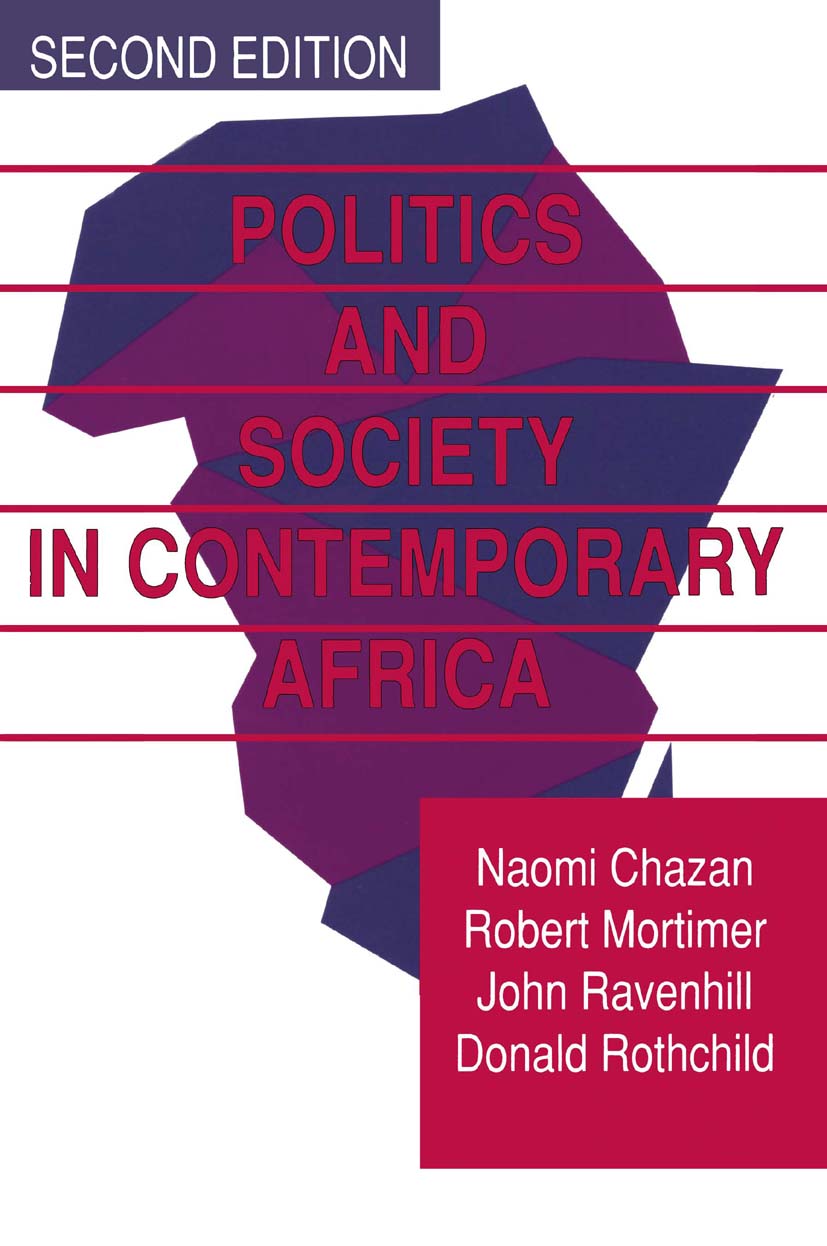
Politics and Society in Contemporary Africa Africa has undergone significant political, economic, and social change since the first edition of this book was published in early 1988. Now revised and updated throughout, this new edition includes current economic, social, and political data, as well as entirely new sections on the dismantling of apartheid, civil society, democratization and multiparty politics, economic reform and structural adjustment, and the prospects for African development in the twenty-first century. Review comments on the first edition: 'Required reading for any course on politics and society of the African continent' West Africa 'The best available textbook on the subject...this volume stands unchallenged in its comprehensiveness and sophistication.' Choice POLITICAL SCIENCE,World,African
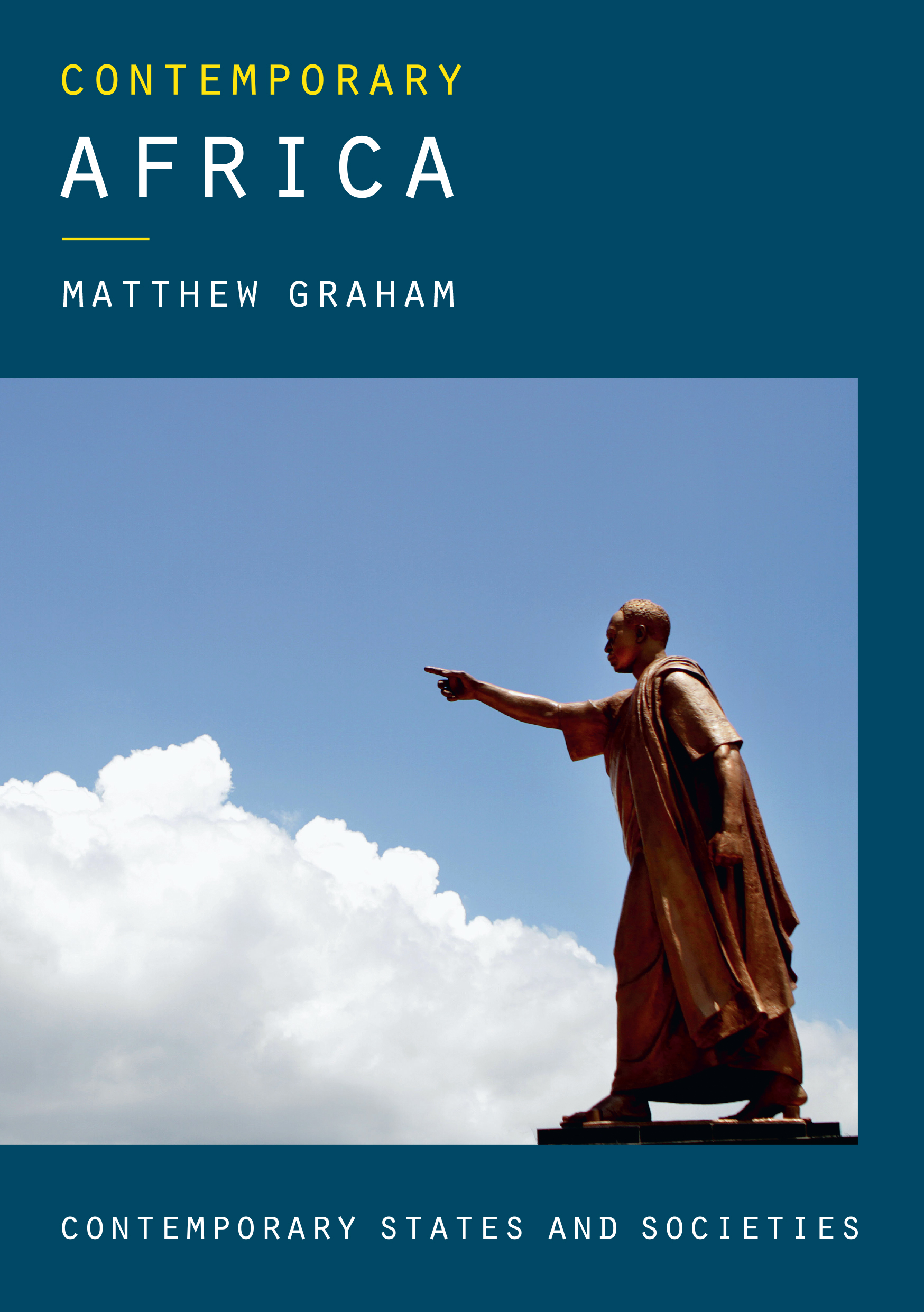
Contemporary Africa A wide-ranging critical introduction to contemporary Africa, written in an accessible style. A brief introduction to the historical context, the countries and their peoples provides a backdrop to broad-ranging coverage of politics, economy, society and culture and of the continent's prospects today. POLITICAL SCIENCE,World,African
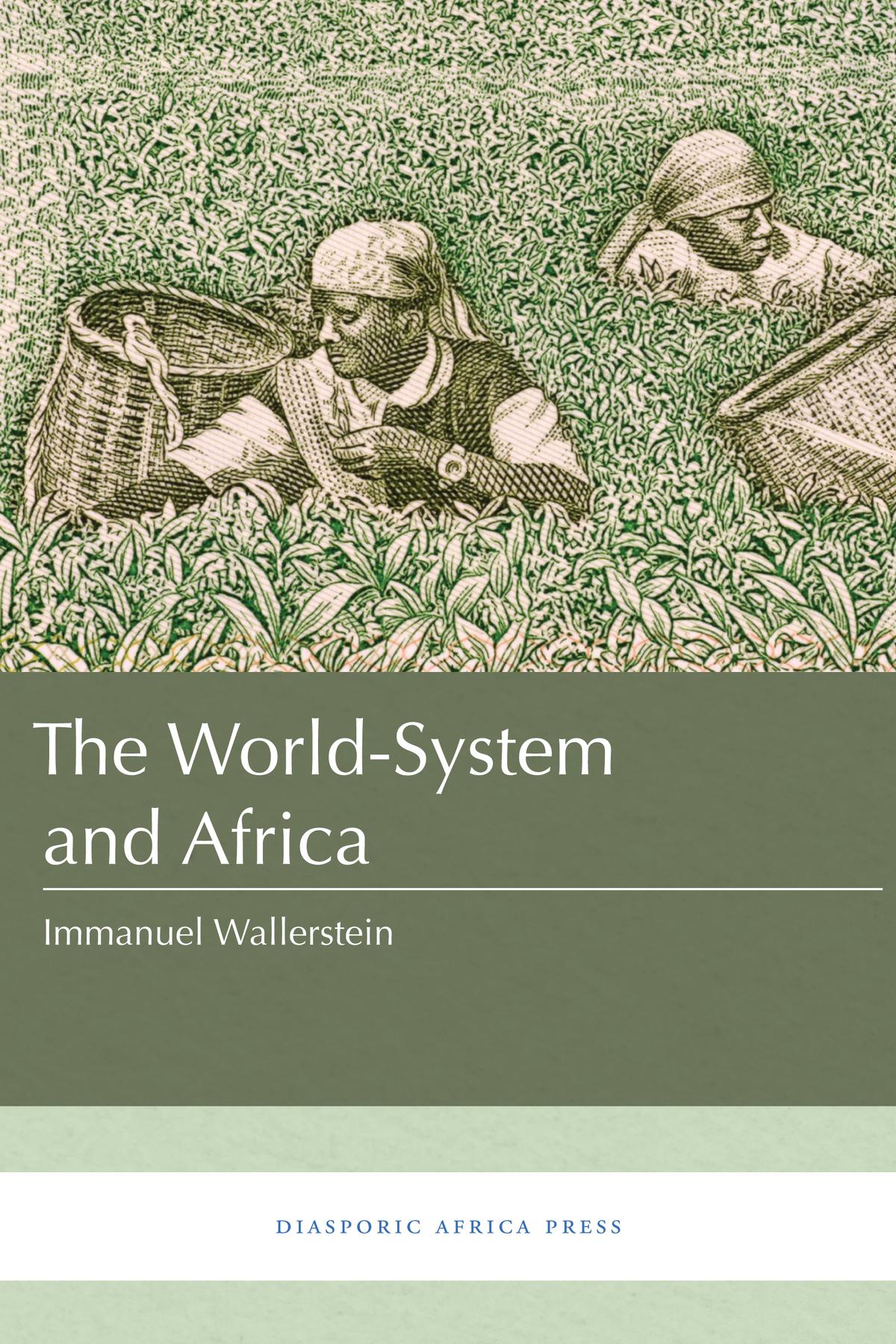
The World-System and Africa In The World-System and Africa, Immanuel Wallerstein examines three important, interconnected themes that link Africa and the capitalist world-system of the last 500 years. While drawing attention to the structural crisis of the modern world-system, Wallerstein uses the first set of essays to explore the impact of this worldwide structural crisis on Africa. Next, he turns to identity politics, a political stance that came to prominence in the last thirty years, and considers the world-system context for the African dilemmas posed by this approach. Not unique to Africa, identity politics has become central to political struggles everywhere in the world-system. Finally, Wallerstein reflects on African thinkers’ analyses of current affairs both in the world-system and in Africa. Coming from someone who has been involved in writing about Africa for over seventy years, Wallerstein argues that if Africa is going to play an appropriate and significant role in resolving the structural crisis of the modern world-system, it is crucial that there continue to be a well-informed and intellectually relevant debate about the issues involved, the moral choices to be made, and the political strategies to follow. POLITICAL SCIENCE,World,African

Corruption and Informal Practices in the Middle East and North Africa This book investigates the pervasive problem of corruption across the Middle East and North Africa. Drawing on the specifics of the local context, the book explores how corruption in the region is actuated through informal practices that coexist and work in parallel to formal institutions. When informal practices become vehicles for corruption, they can have negative ripple effects across many aspects of society, but on the other hand, informal practices could also have the potential to be leveraged to reinforce formal institutions to help fight corruption. Drawing on a range of cases including Morocco, Lebanon, Turkey, Jordan, Tunisia or Israel the book first explores the mechanisms and dynamics of corruption and informal practices in the region, before looking at the successes and failures of anti-corruption initiatives. The final section focuses on gender perspectives on corruption, which are often overlooked in corruption literature, and the role of women in the Middle East. With insights drawn from a range of disciplines, this book will be of interest to researchers and students across political science, philosophy, socio-legal studies, public administration, and Middle Eastern studies, as well as to policy makers and practitioners working in the region. POLITICAL SCIENCE,World,African

Infrastructure Development in Nigeria This book examines the politics and economics of infrastructure development in Nigeria from Independence in 1960 up to 2015, and the role of good governance in promoting the socioeconomic wellbeing of citizens. Arguing for the need for transformational leadership in infrastructure development, the chapters examine policy issues and survey the various administrative, economic, and social-political reforms that have impacted infrastructure development in Nigeria. The author also discusses current national development plans and Vision 20:2020; challenges to infrastructure development, including corruption; and the future potential of a strong infrastructure network for the economy and citizens. Drawing upon his experience within government departments, as well as existing models of leadership and governance, the author explores the role of infrastructure development in promoting the wellbeing and growth of Nigeria. Combining theory with practical examples of good governance, this book will be of interest for students and researchers of political science and infrastructure development in Africa. POLITICAL SCIENCE,World,African

Indigenous Knowledge Systems and Development in Africa This edited volume analyzes African knowledge production and alternative development paths of the region. The contributors demonstrate ways in which African-centered knowledge refutes stereotypes depicted by Euro-centric scholars and, overall, examine indigenous African contributions in global knowledge production and development. The project provides historical and contemporary evidences that challenge the dominance of Euro-centric knowledge, particularly, about Africa, across various disciplines. Each chapter engages with existing scholarship and extends it by emphasizing on Indigenous knowledge systems in addition to future indicators of African knowledge production. POLITICAL SCIENCE,World,African
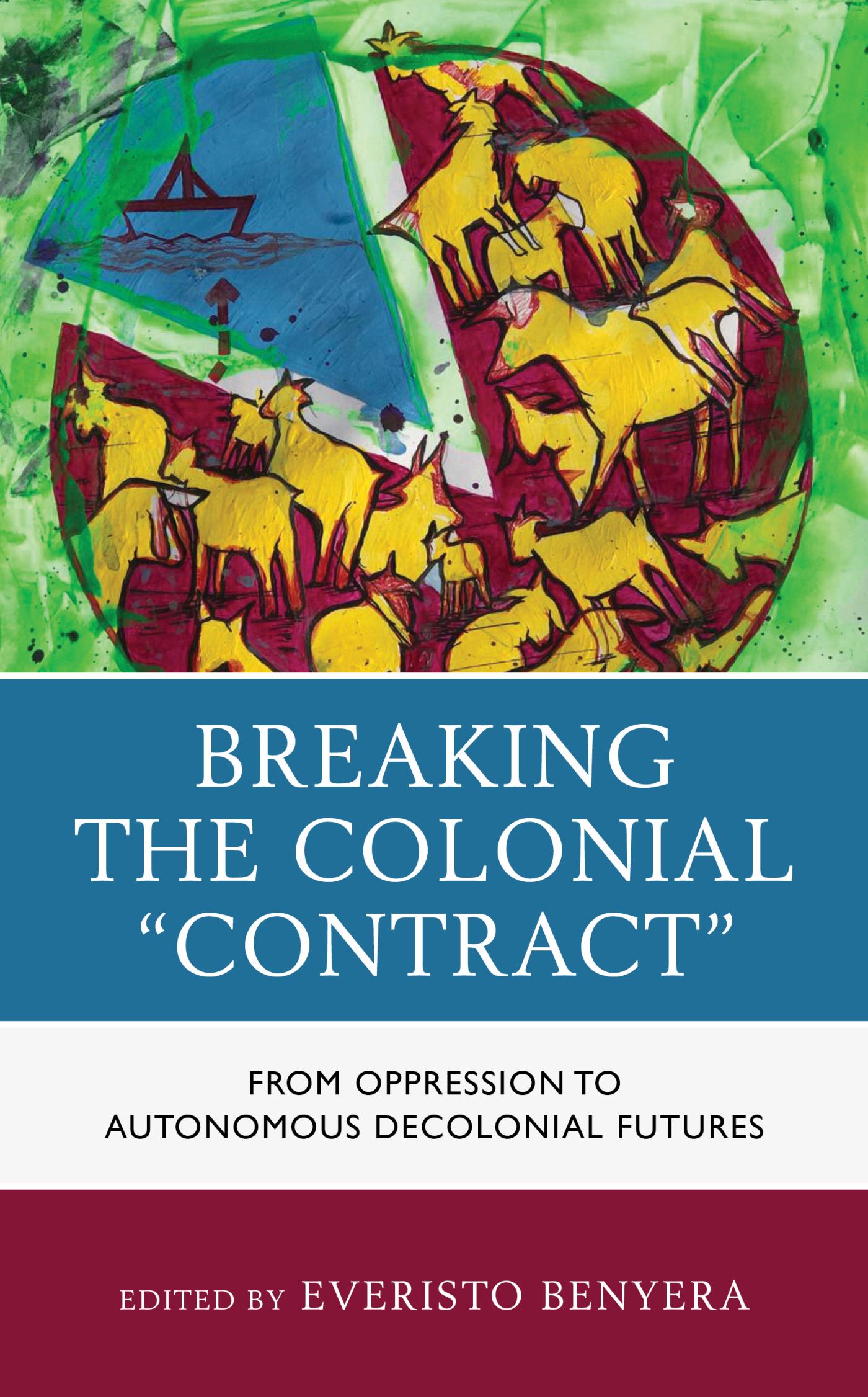
Breaking the Colonial "Contract" The book characterizes colonialism as a duress contract entered into by the colonized and enforced by the colonizers. The contributors argue that the colonial "contract" must be voided because of the dehumanization and oppression implied. Only when unmasked and fully comprehended can colonialism be halted. POLITICAL SCIENCE,World,African
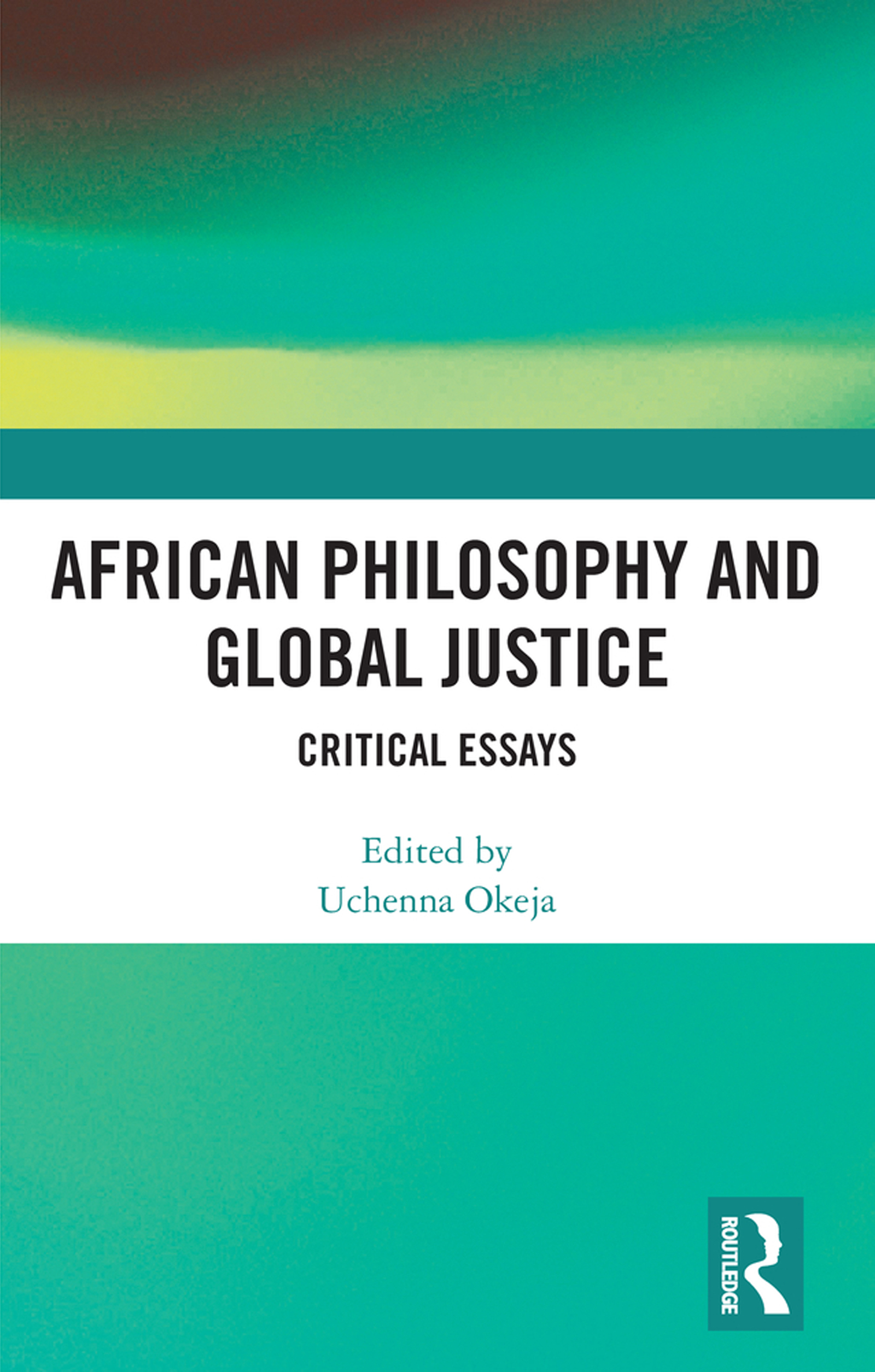
African Philosophy and Global Justice In contemporary political philosophy, the subject of global justice has received sustained interest. This is unsurprising, given the nexus between inequality and many of the pressing global problems today, such as immigration, global public health, poverty and violence. Theorists of global justice ask why inequality is morally wrong, what we owe to the global poor, what the implications of global inequality for people in affluent countries are, and the power of agencies or institutions necessary for the realization of a fairer world. Although political philosophers have offered different conceptions of these problems and narratives of the ideal of justice, a major shortcoming of the current discussion are the limits of the concepts and idioms employed. Assumptions are made about the experience of poverty, but little is done to understand the way people in underdeveloped countries experience and understand their predicament. This has resulted in the entrenchment of cognitive inequality in the global justice debate. This book attempts to correct the inaccuracies engendered by the one-sided theorising of global justice. By employing metaphors, concepts and philosophical ideas to reflect on global justice, the book provides an account of global justice that goes beyond current parochial perspective. This book was originally published as a Special Issue of Philosophical Papers. POLITICAL SCIENCE,World,African
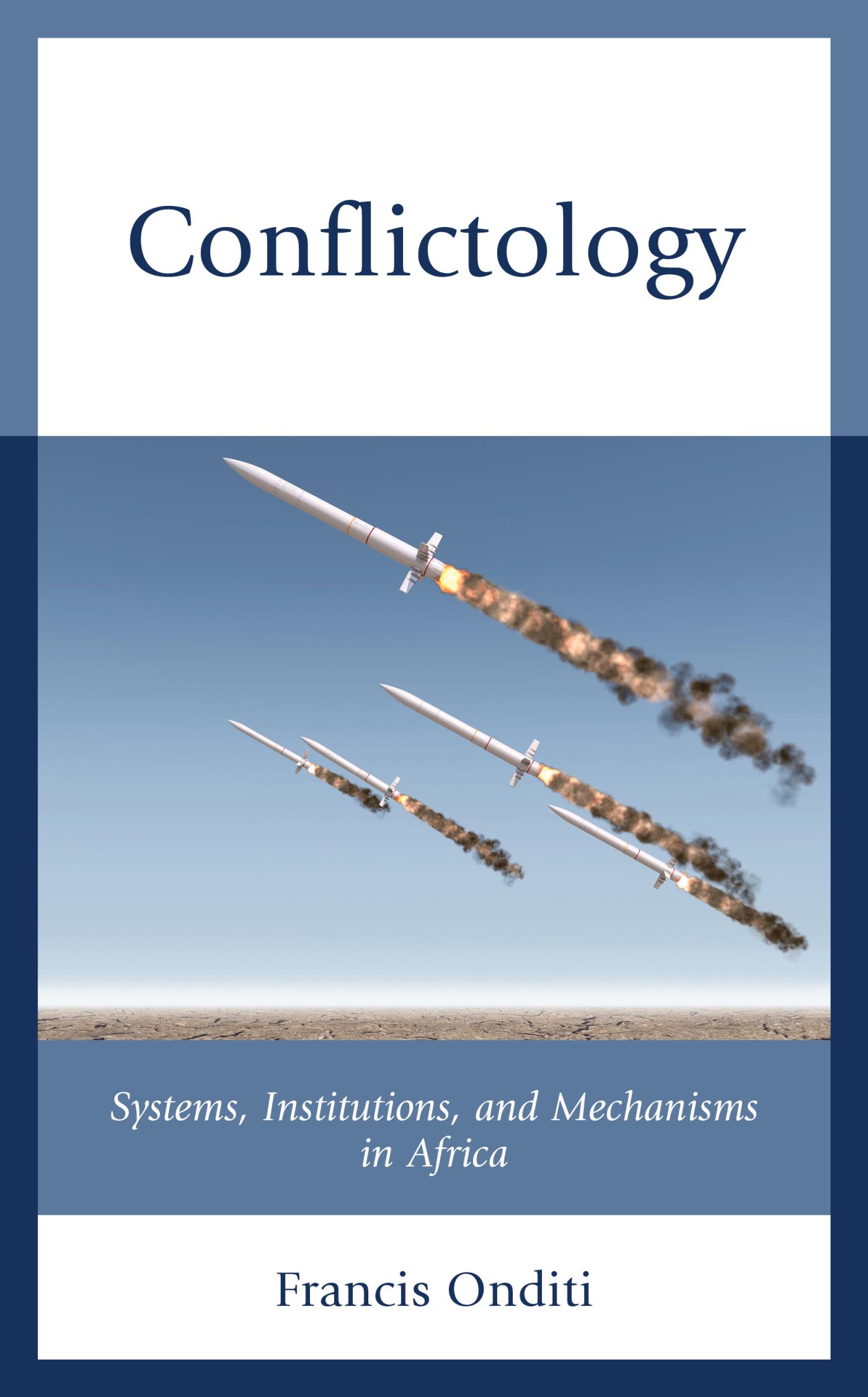
Conflictology This book argues that the changing nature of conflict, taking the form of radicalization and extremism, is deeply rooted in an individual's ideology, personality, biology, and psychology. Onditi deploys an interdisciplinary approach to understanding conflict through human behavior. POLITICAL SCIENCE,World,African

Oil Revenues, Security and Stability in West Africa This book offers a new look at the oil industry in West Africa, proposing to examine the entire region that has been viewed through the lens of Nigeria, Ghana and Gabon. The author argues that, in order to address peace and stability in the region, it is important to understand the transformative powers of petroleum revenue. The project also includes the author’s analysis of the problem on multiple levels: international oil companies, states, and local communities. Also, it takes a deeper look at the effects and importance of local communities in the above countries and discusses adequately the strategic challenges that petro-capitalism poses for West Africa’s regional stability and human security. POLITICAL SCIENCE,World,African
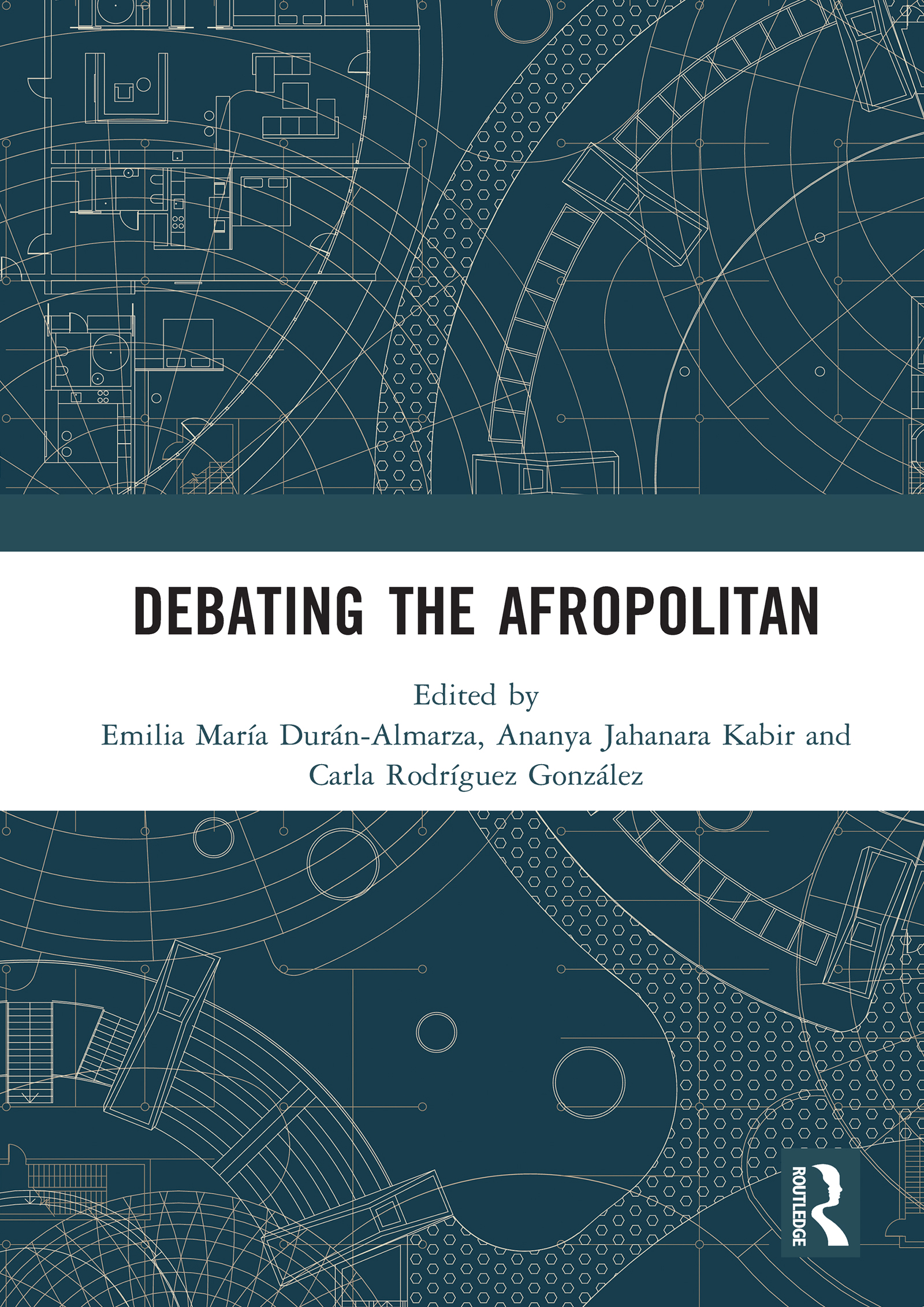
Debating the Afropolitan This volume evaluates the vitality of the term ‘Afropolitan’ within the fields of African and Afro-diasporic studies. A hotly debated and malleable term, its wide circulation has allowed for Afropolitanism to become a contested space for critical inquiry. The contributions to this book are representative of the lively discussions that Afropolitan aesthetics, identity politics and Afro(cosmo)politanisms have sparked in recent years. The book aims to continue the debates around these concepts foregrounded by earlier works in the fields of postcolonial literature, African cultural studies, and studies of diaspora and transnationalism. This book was originally published as a special issue of the European Journal of English Studies. POLITICAL SCIENCE,World,African

Committed Theatre in Nigeria This book identifies Nigerian theatre as a highly creative and useful tool for cultural and economic development. It moves beyond the usual discussion of theatre as entertainment to a dialogue that situates theatre as an essential tool for initiating public discourse for the advancement of society in general. POLITICAL SCIENCE,World,African
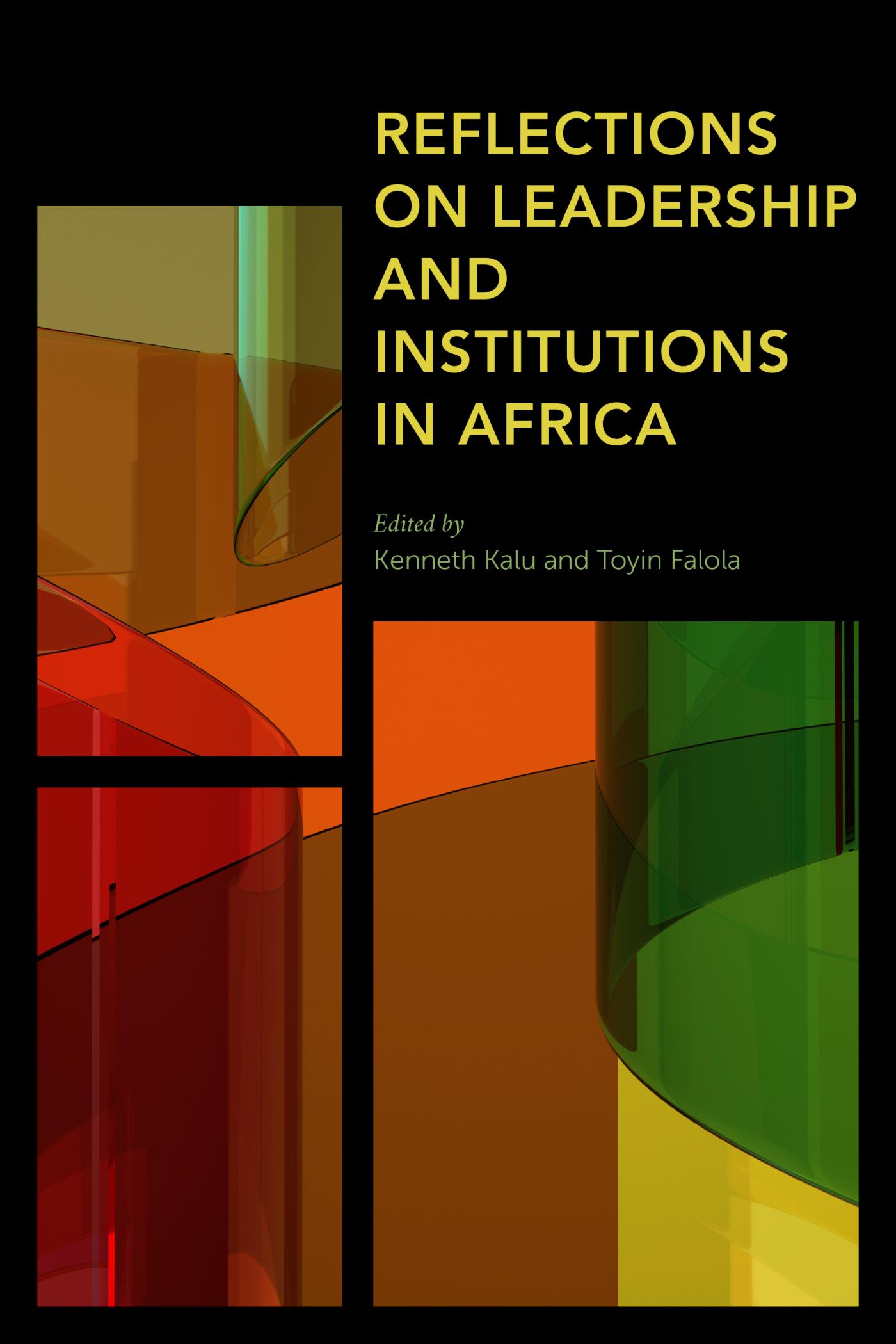
Reflections on Leadership and Institutions in Africa This book explores the nature and impacts of leadership and institutions on Africa’s development. POLITICAL SCIENCE,World,African
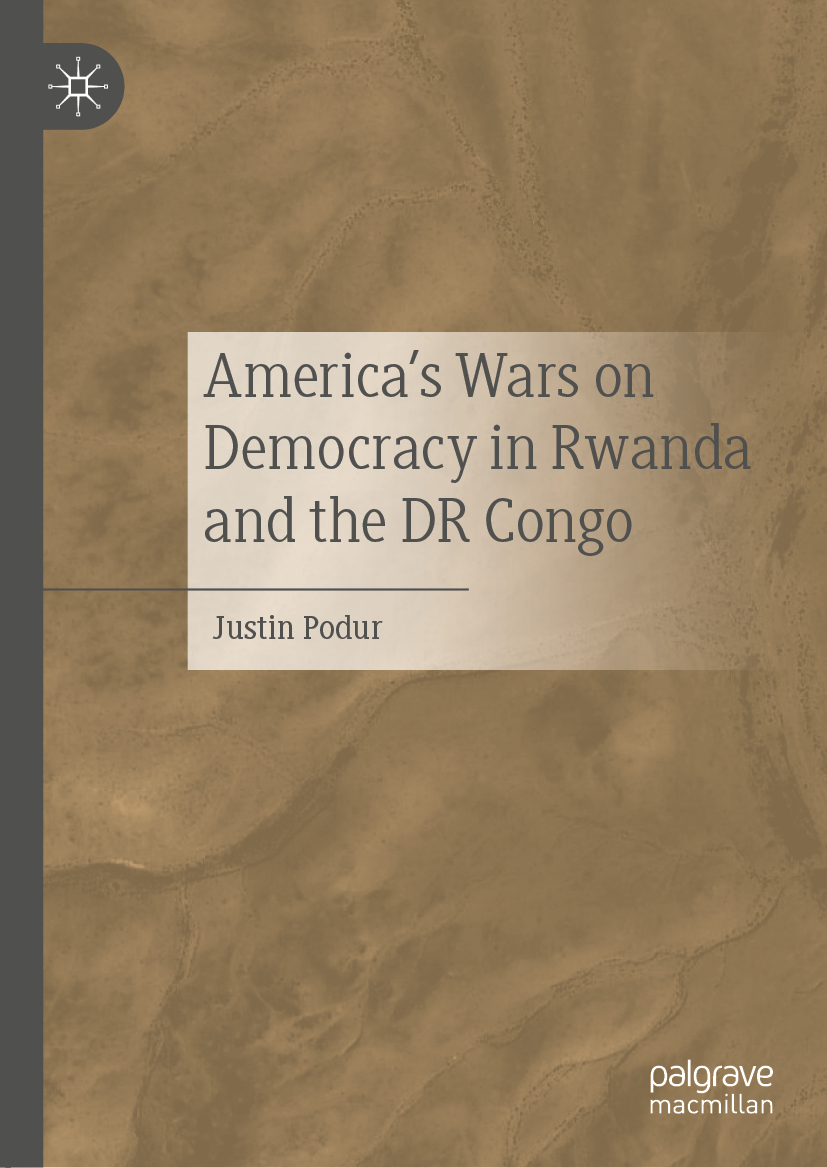
America's Wars on Democracy in Rwanda and the DR Congo This book examines US interventions in the Democratic Republic of the Congo and Rwanda -- two countries whose post-independence histories are inseparable. It analyzes the US campaigns to prevent Patrice Lumumba from turning the DR Congo into a sovereign, democratic, prosperous republic on a continent where America’s ally apartheid South Africa was hegemonic; America’s installation of and support for Mobutu to keep the region under neo-colonial control; and America’s pre-emption of the Africa-wide movement for multiparty democracy in Rwanda and Zaire in the 1990s by supporting Paul Kagame’s Rwandan Patriotic Front (RPF). In addition, the book discusses the concepts of African development, democracy, genocide, foreign policy, and international politics. POLITICAL SCIENCE,World,African
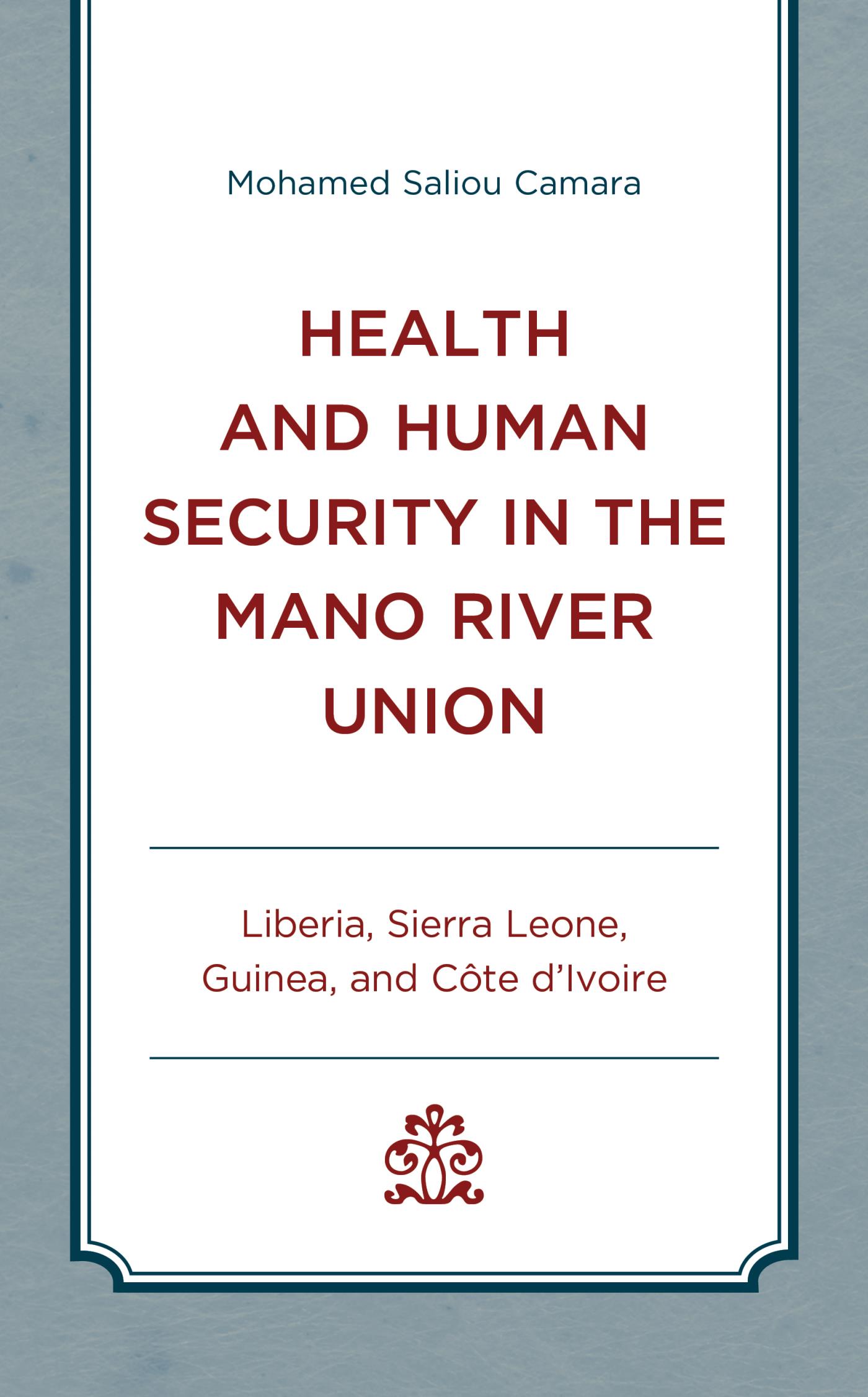
Health and Human Security in the Mano River Union This book studies the challenges facing Liberia, Sierra Leone, Guinea and Côte d’Ivoire relative to sustainable security in the areas of health, food, environment, law and order and governance in the wake of the armed conflicts and Ebola outbreak that rocked the Mano River Union sub-region in the late twentieth and early twenty-first centuries. POLITICAL SCIENCE,World,African

Political Violence and Oil in Africa The book argues that in order to better understand the undercurrents of the Niger Delta conflict, it is imperative to analyse the dynamics of choice in terms of the distinct courses of action taken by the Ogoni and Ijaw. Given the similar structural constraints, the author considers why the Ogoni adopted nonviolent resistance, and the Ijaw violent resistance. This book is divided into seven chapters starting with an introduction to oil and political violence in African conflicts, and includes a synoptic overview of four other resource-rich countries in Africa. Theoretical and conceptual underpinnings of conflict are then presented with the aim of situating the Niger Delta conflicts within the wider conflict literature. Chapter Three concentrates the discussion on the Nigerian Niger Delta, outlining the core issues at the centre of the contestations. The following three chapters offer an in-depth empirical analysis on the interaction between the narratives on nonviolence versus violence, the nature of leadership styles, and the organisation of the Ogoni and Ijaw movements along with a concluding chapter. POLITICAL SCIENCE,World,African
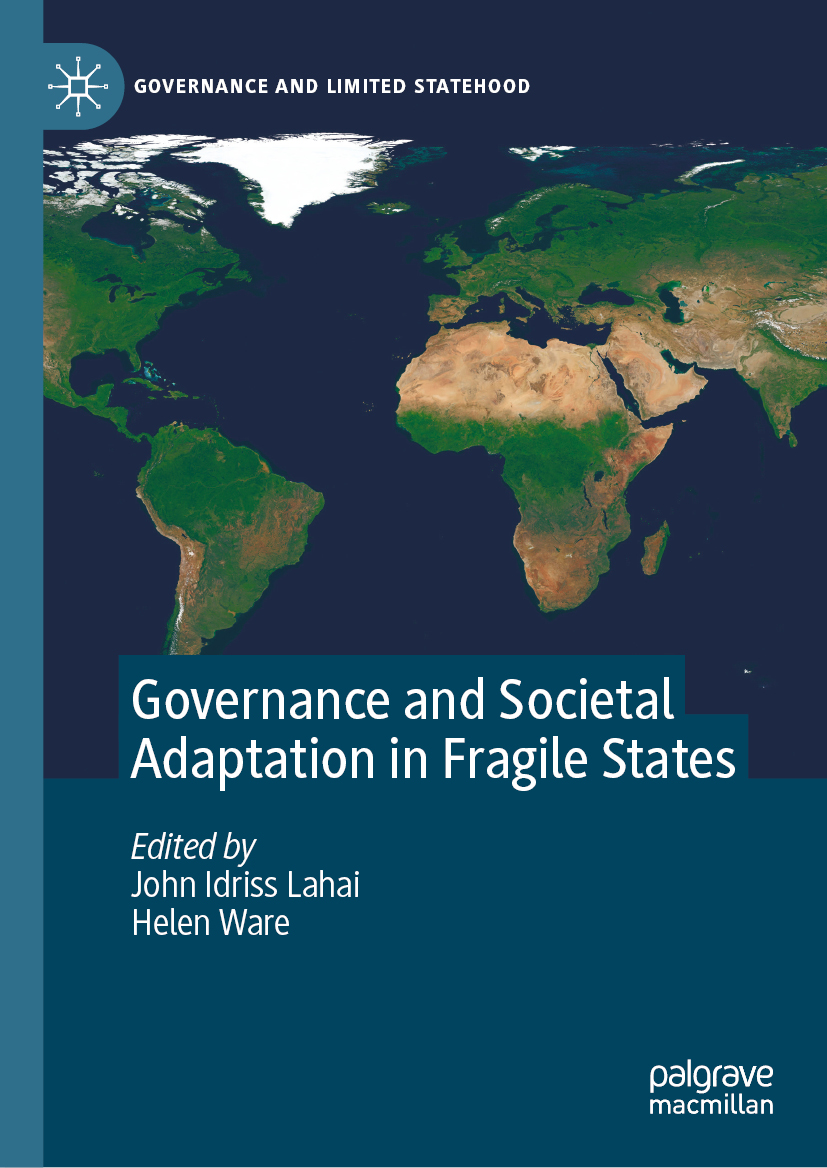
Governance and Societal Adaptation in Fragile States This book examines the various ways in which some fragile states in the Global South (or states with limited statehood) have adopted, and adapted to, processes of governance in their quests to address the socialized problems affecting their societies. It tells the story of these states’ resilience in the societal adaptation to a liberalized notion of governance. In addition to comparative case studies, the book also analyzes the engendered interplay of culture, economics, and politics in the creation of people-centric governance reforms. The contributing authors shed light on weak states’ often constructive engagement in the promotion of state governance under a variety of societal conditions, adverse or otherwise, and on their ability to remain resilient despite the complexities of the political and economic challenges they face. POLITICAL SCIENCE,World,African

Democratic Practice and Governance in Nigeria This book examines the challenges confronting the practice of democracy and governance in Nigeria. The book examines the theoretical underpinnings and the procedural and institutional components of democratic practice in Nigeria, including the challenges associated with elections, the legislature, the media and gender issues. Approaching the pluralistic characteristics of the Nigerian state and how they impede democratisation through contributions by experts and scholars in the field, the book analyses the issues and nuances inherent to governance and democracy in Nigeria, as well as domestic policy process, global governance and human security. Democratic Practice and Governance in Nigeria will be of interest to students and scholars of African politics and democratisation. POLITICAL SCIENCE,World,African
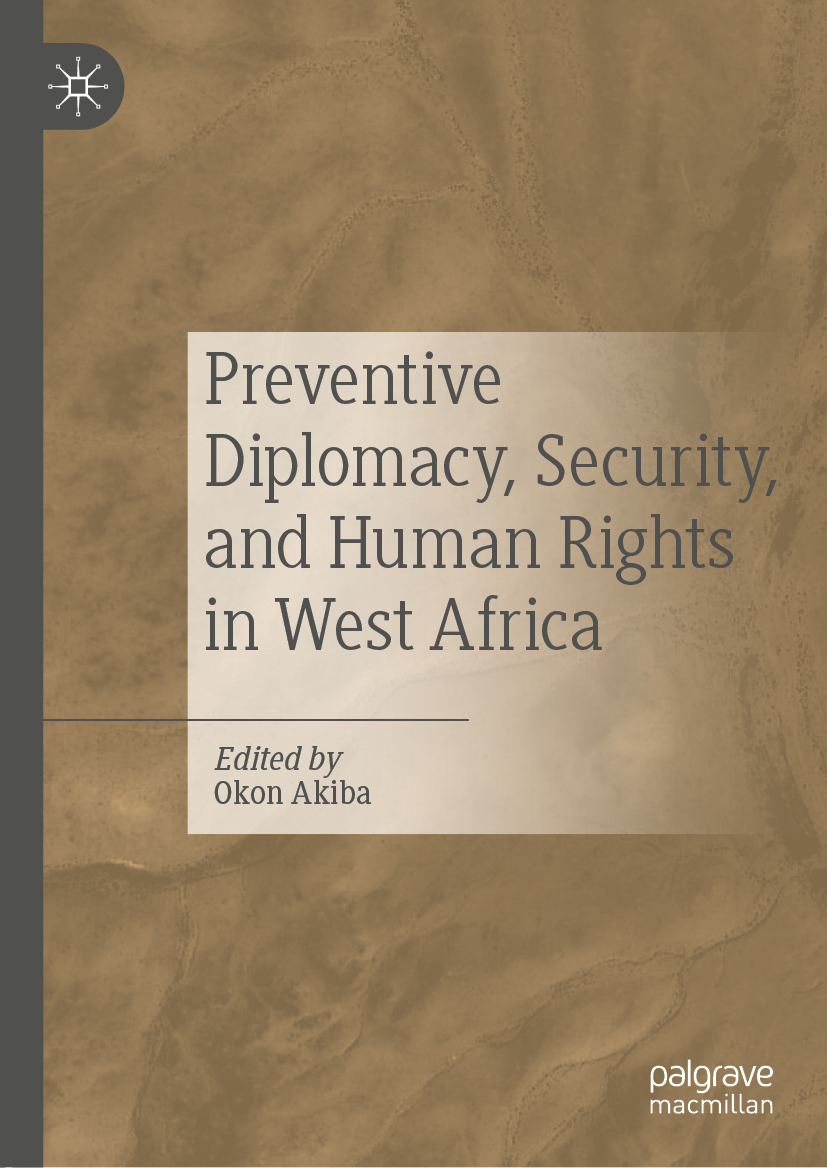
Preventive Diplomacy, Security, and Human Rights in West Africa This edited volume focuses on the development and conflict prevention mechanism of the Economic Community of West African States, ECOWAS. The contributors discuss complex socio-political and economic issues and use a cross disciplinary approach to treat most of the dominant research questions in the field. The chapters come nicely together in a kaleidoscope of knowledge deriving from scholarly investigative traditions in political science, anthropology, economics, law, and sociology. The book is conceived as a source of reference and for graduate courses in African politics, development, human rights, transnational law, and international public policy. POLITICAL SCIENCE,World,African

Music and Peacebuilding This book examines music as a means of making peace. It is a multidisciplinary study, grounded in peace studies and musicology that reflects on whether the creative arts can promote healing and reconciliation, within communities, in pedagogy and in national - and international - popular culture. POLITICAL SCIENCE,World,African

Aid Donor Collaboration, Organizational Behavior, and Aid Flow Predictability This book provides four strategic recommendations to address challenges inherent in the collaboration between donors and aid agencies. Bell discusses the role of organizational behavior in aid flow predictability, places for improvement, and whether collaborations between people with different interests can meaningfully address societal problems. POLITICAL SCIENCE,World,African
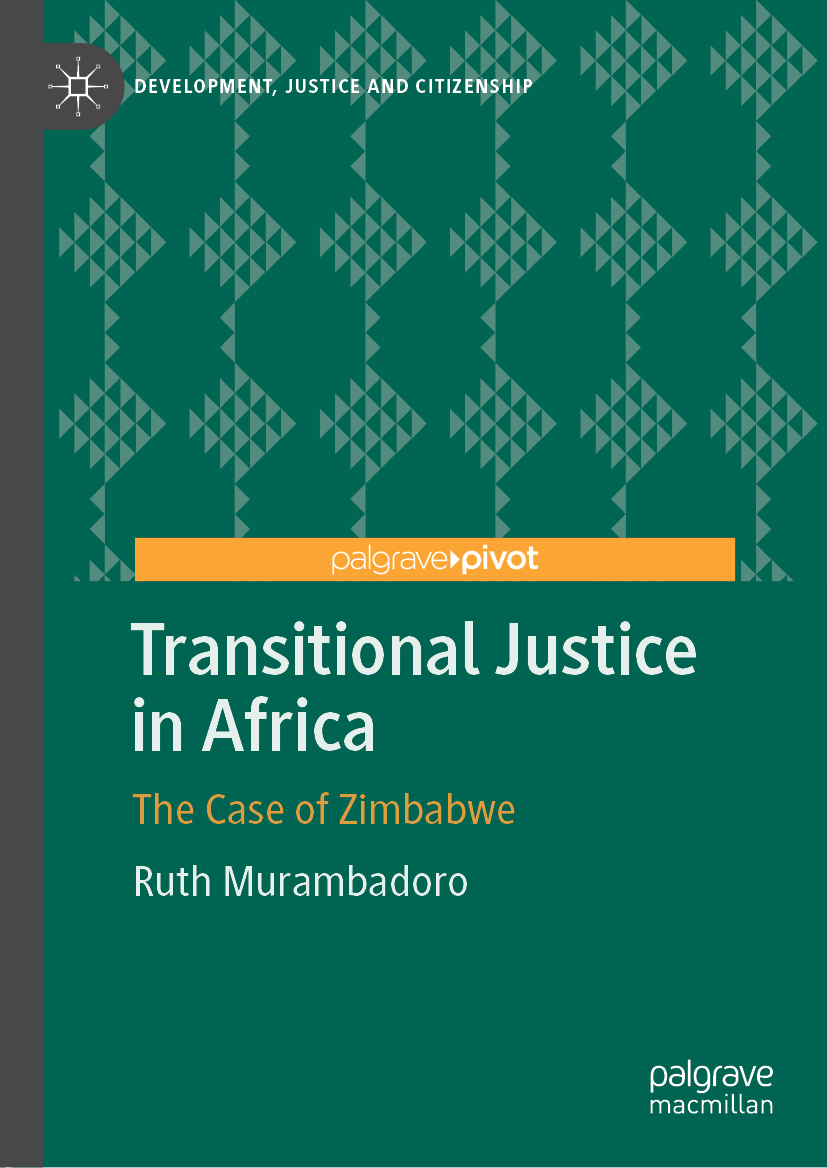
Transitional Justice in Africa This book provides insight on the effect of political violence and transitional justice in Africa focusing on Zimbabwe and comparing it to Rwanda, Uganda and Mozambique. The case of Zimbabwe is unique since political violence observed in some areas has manifested as contestations for power between members of various political parties. These political contestations have infiltrated family/clan structures at the community level and destroyed the human and social relations of people. Also, the author examines an understanding of how communities in the most polarized and conflict-ridden areas in Africa are addressing their past. The project would appeal to graduate students, academics, researchers and practitioners as it will help them to understand African justice systems and the complex network of relationships shaping justice processes during transitions. POLITICAL SCIENCE,World,African
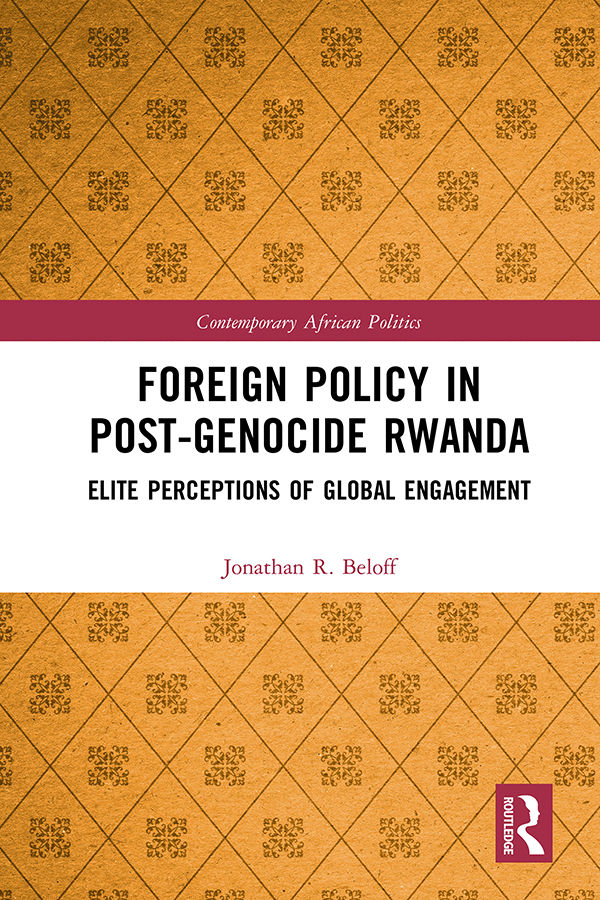
Foreign Policy in Post-Genocide Rwanda This book examines how Rwandan elites within the government, private sector and civil society perceive the nation’s political and economic relationship with the international community. Using testimonies and interviews of Rwandan political, military and economic leaders, and bureaucrats, this book examines the intersubjective beliefs that formulate how Rwanda engages with the international community. The book presents and analyses three primary intersubjective themes: historical and possible future abandonment of Rwanda; implementing an ideology of agaciro to promote self-respect, dignity and self-reliance for state security and economic development; and the belief in the government’s obligation to promote human security for those who identify as ‘Rwandan’. These perceptions help us understand how post-genocide Rwanda engages with the international community in the pursuit of state security, economic development and to prevent a future genocide. This book will be of interest to students and scholars of African politics and international relations as well as the politics of post-genocide states. POLITICAL SCIENCE,World,African
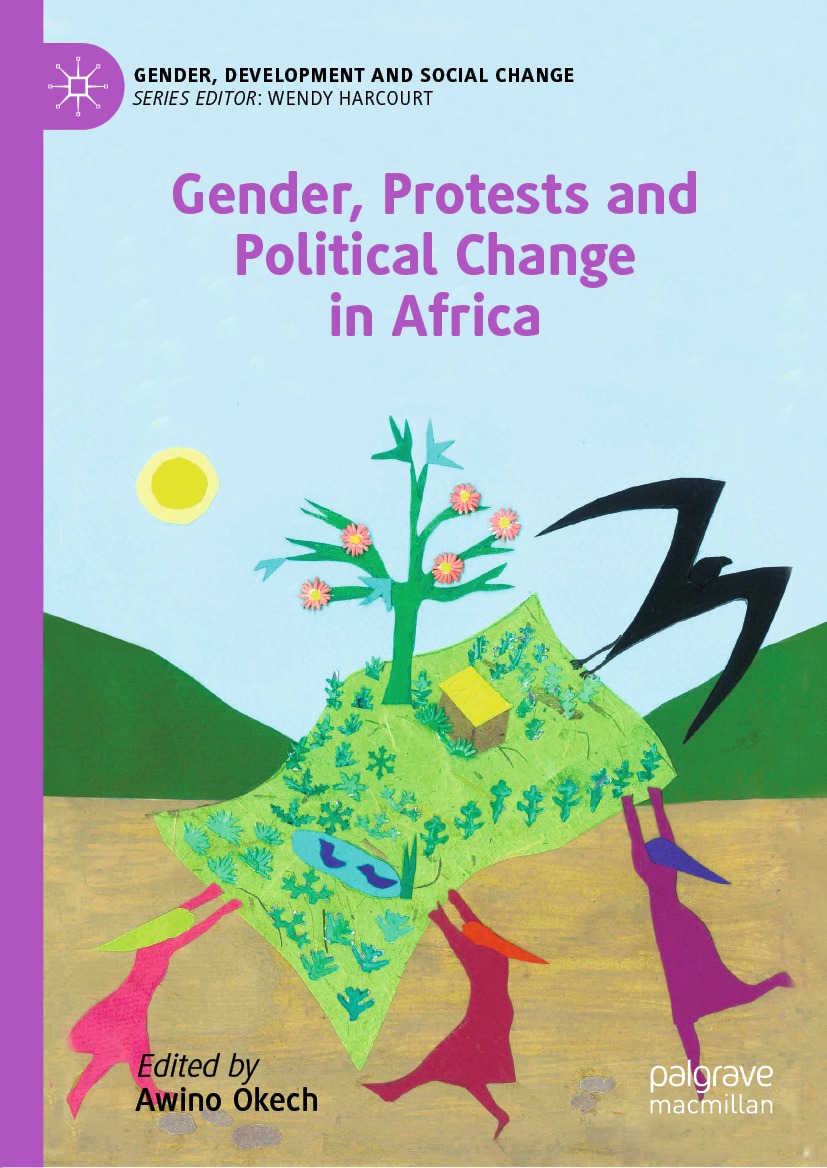
Gender, Protests and Political Change in Africa This book brings together conceptual debates on the impact of youth-hood and gender on state building in Africa. It offers contemporary and interdisciplinary analyses on the role of protests as an alternative route for citizens to challenge the ballot box as the only legitimate means of ensuring freedom. Drawing on case studies from seven African countries, the contributors focus on specific political moments in their respective countries to offer insights into how the state/society social contract is contested through informal channels, and how political power functions to counteract citizen’s voices. These contributions offer a different way of thinking about state-building and structural change that goes beyond the system-based approaches that dominate scholarship on democratization and political structures. In effect, it provides a basis for organizers and social movements to consider how to build solidarity beyond influencing government institutions. POLITICAL SCIENCE,World,African
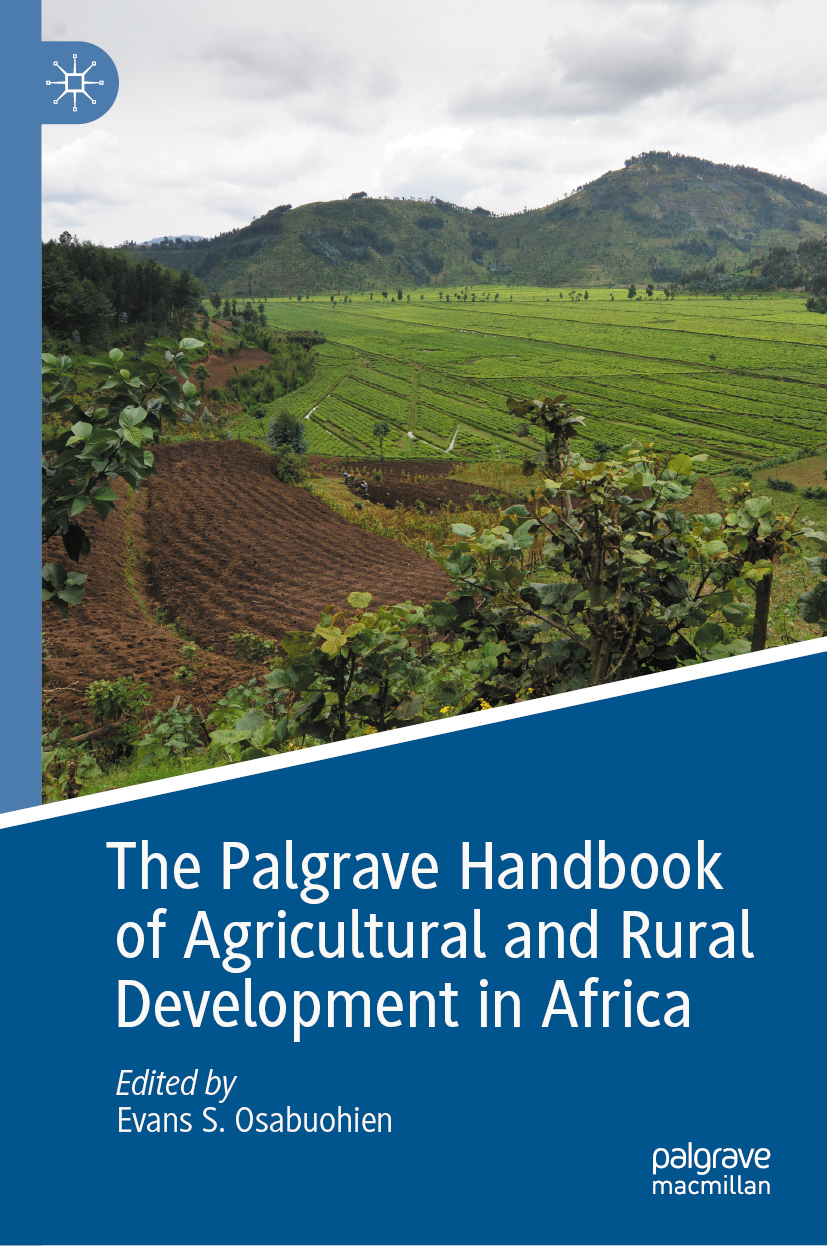
The Palgrave Handbook of Agricultural and Rural Development in Africa This handbook examines agricultural and rural development in Africa from theoretical, empirical and policy stand points. It discusses the challenges of the United Nations Sustainable Development Goals (SDGs) and assesses how poverty and other development concerns can be addressed in rural communities through agricultural transformation. Additionally, the handbook extends the Post-2015 Development Agenda and it emphasizes the importance of the agricultural sector as it is closely related to the issues of food sustainability, poverty reduction, and employment creation. The contributors suggest multiple evidence-based policies to develop the rural areas through the transformation of the agricultural sector which can significantly benefit the African continent. POLITICAL SCIENCE,World,African
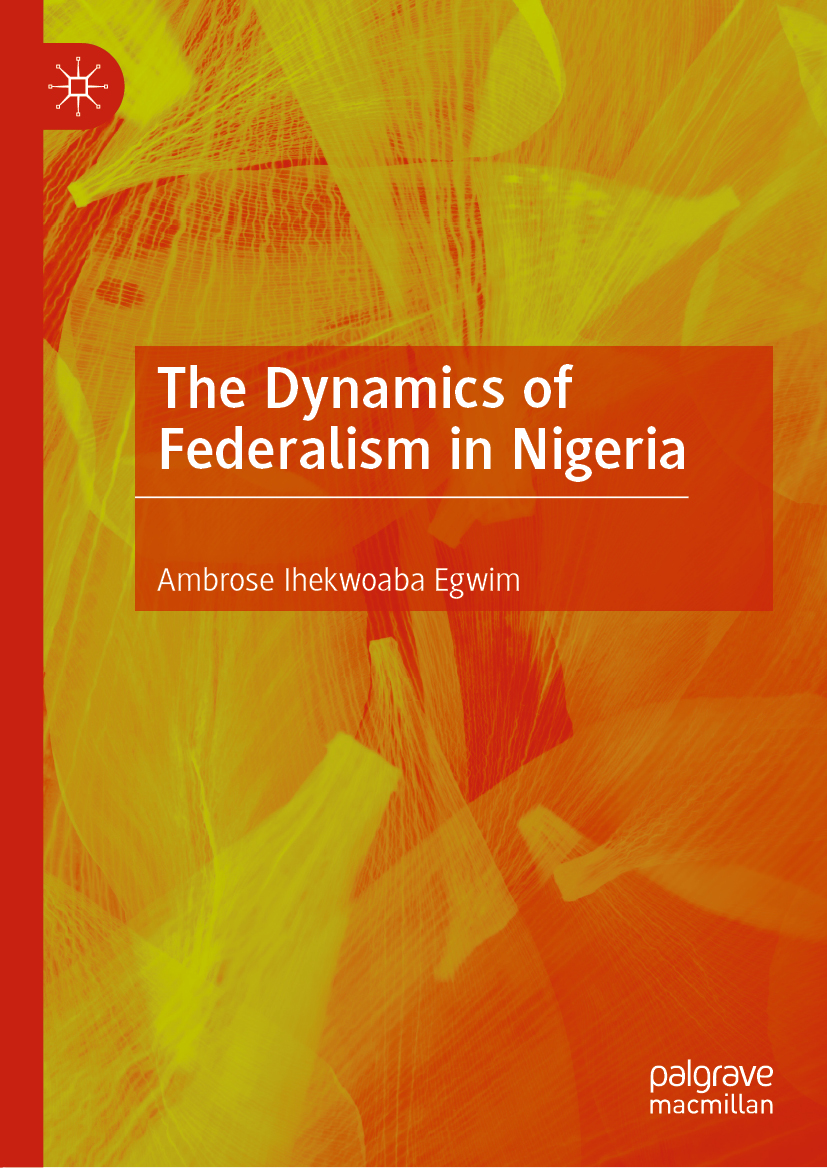
The Dynamics of Federalism in Nigeria This book analyzes the concept “true federalism†to examine whether there are definable dimensions of power-sharing that make ‘true federalism.’ The author takes a critical look at dimensions on political restructuring in Nigeria, which have been termed “true federalism.†The work fills a significant gap in the existing literature on the theory and practice of federalism. The project will be useful to the students and professors of African Studies, political science, Nigeria federalism, public administration and policy. Additionally, the monograph will be interesting to the general public who seek to know more about contemporary issues in Nigeria. POLITICAL SCIENCE,World,African
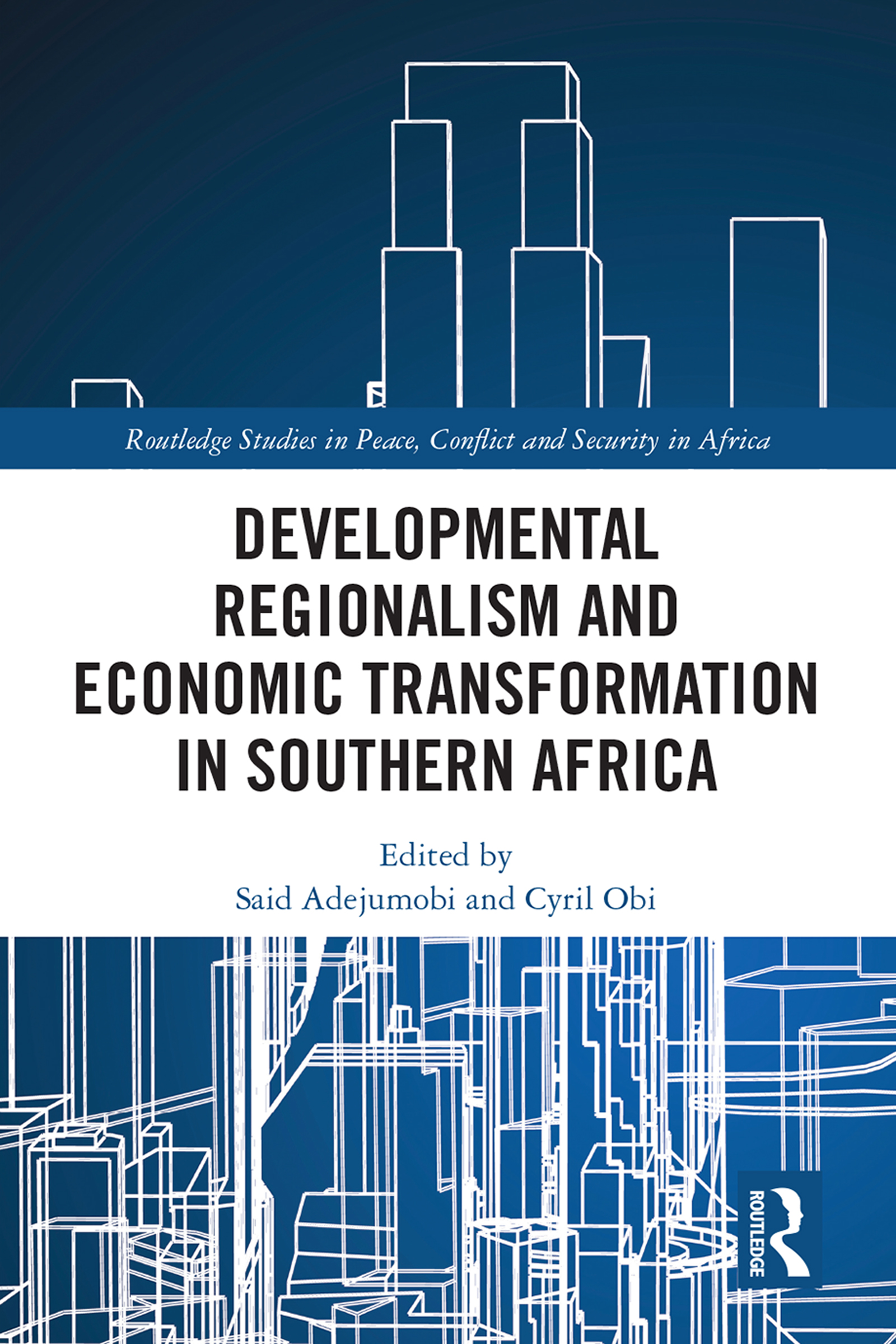
Developmental Regionalism and Economic Transformation in Southern Africa Interrogating the notion of developmental regionalism as applies to Southern Africa, this volume explores the policy options and interventions necessary to ensure a peaceful and stable regional development process. With a focus on the Southern African Development Community (SADC), the contributions explore how regional institutions such as this can be drivers of developmental regionalism. Institutional architecture, along with key policy priorities, and implementation strategies in areas such as trade, industry, agriculture, private sector development and conflict management are analysed, and the ramifications of regional interventions for peace building and regional security in post-conflict Southern African countries are explored. Drawing on this analysis the book proffers key policy options and strategies for how developmental regionalism can be both consummated and sustained, ultimately driving economic transformation. Illustrating to policymakers, scholars and development practitioners how regional institutions can be engines or facilitators of regional development, the book will be of interest to researchers in a broad range of areas including development studies, public policy and African studies. POLITICAL SCIENCE,World,African
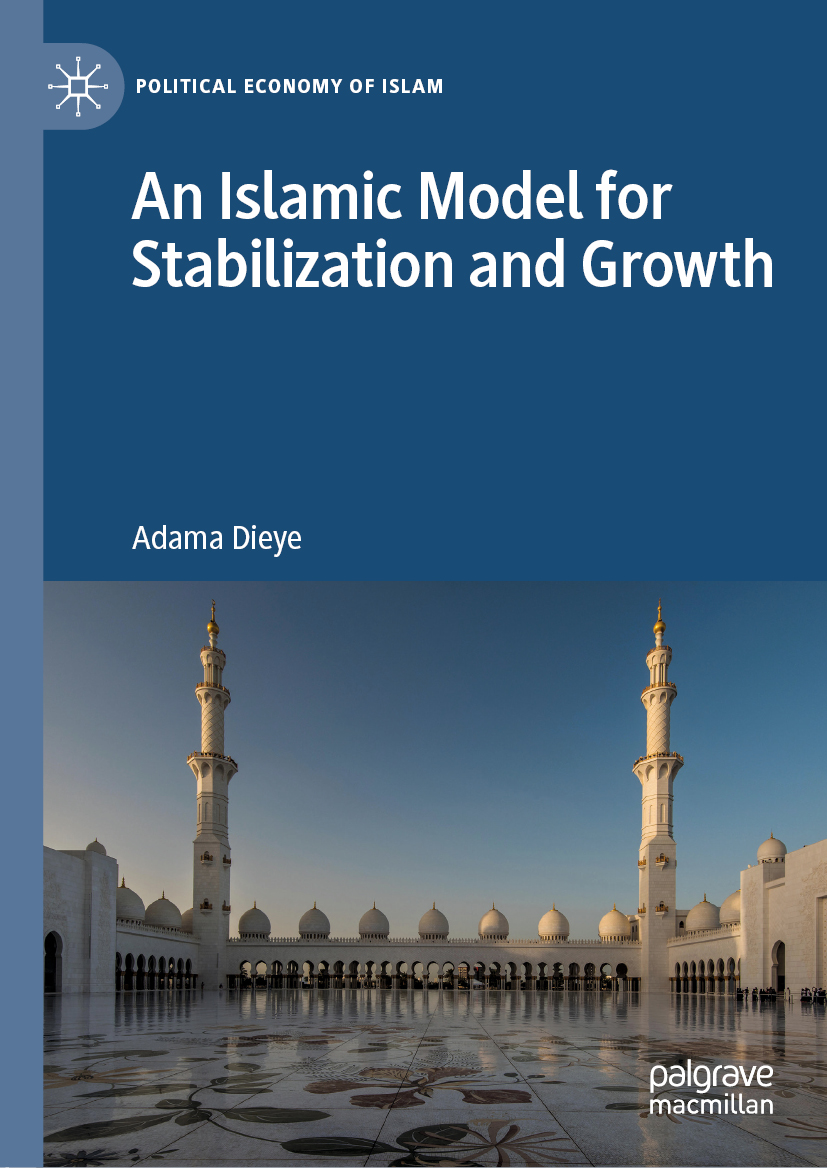
An Islamic Model for Stabilization and Growth This book argues that the macroeconomic policy adjustment models recommended by the IMF and the World Bank for implementation in many Muslim countries, with substantial donor financial support, have not been effective. Economic indicators show low economic growth, persistent fiscal and external deficits and limited industrialization. Also, these countries are experiencing increases in unemployment, poverty and substantial growth in income and wealth ‎inequalities. These facts ‎underline an urgent need to produce an alternative to the failed conventional macroeconomic model in order to address the challenge of ‎macroeconomic and social adjustment policies. The project posits and investigates the idea that the Islamic economic model prescribed in the Quran and applied by the Prophet (sawa) could be the ideal model for Muslim as well as non-Muslim ‎countries. POLITICAL SCIENCE,World,African
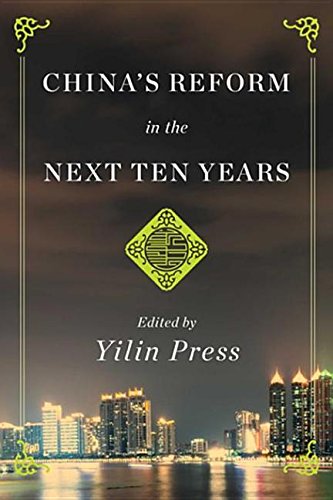
China's Reform in the Next Ten Years A collection of essays by leading Chinese political economists about the economic challenges facing China today and the reforms—to everything from financial institutions to urban housing policy—that will be necessary to prepare for the next ten years. POLITICAL SCIENCE,World,Asian

China's Environmental Challenges China's huge environmental challenges are significant for us all. They affect not only the health and well-being of China but the very future of the planet. In the second edition of this acclaimed, trailblazing book, noted China specialist and environmentalist Judith Shapiro investigates China's struggle to achieve sustainable development against a backdrop of acute rural poverty and soaring middle class consumption. Using five core analytical concepts to explore the complexities of this struggle - the implications of globalization, the challenges of governance; contested national identity, the evolution of civil society, and problems of environmental justice and displacement of environmental harm - Shapiro poses a number of pressing questions: Can the Chinese people equitably achieve the higher living standards enjoyed in the developed world? Are China's environmental problems so severe that they may shake the government's stability, legitimacy and control? To what extent are China's environmental problems due to world-wide patterns of consumption? Does China's rise bode ill for the displacement of environmental harm to other parts of the world? And in a world of increasing limits on resources, how can we build a system in which people enjoy equal access to resources without taking them from successive generations, from the vulnerable, or from other species? China and the planet are at a pivotal moment; transformation to a more sustainable development model is still possible. But - as Shapiro persuasively argues - doing so will require humility, creativity, and a rejection of business as usual. The window of opportunity will not be open much longer. POLITICAL SCIENCE,World,Asian
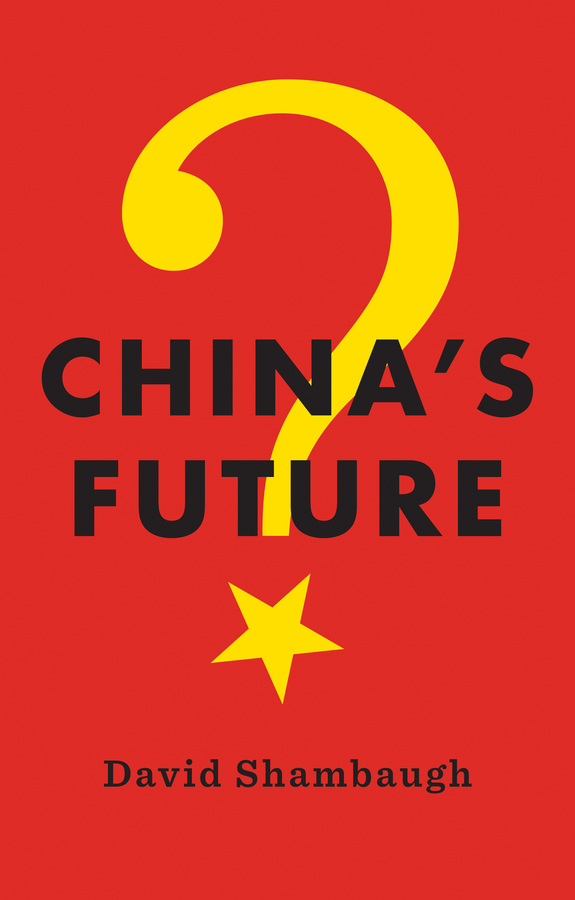
China's Future China's future is arguably the most consequential question in global affairs. Having enjoyed unprecedented levels of growth, China is at a critical juncture in the development of its economy, society, polity, national security, and international relations. The direction the nation takes at this turning point will determine whether it stalls or continues to develop and prosper. Will China be successful in implementing a new wave of transformational reforms that could last decades and make it the world's leading superpower? Or will its leaders shy away from the drastic changes required because the regime's power is at risk? If so, will that lead to prolonged stagnation or even regime collapse? Might China move down a more liberal or even democratic path? Or will China instead emerge as a hard, authoritarian and aggressive superstate? In this new book, David Shambaugh argues that these potential pathways are all possibilities - but they depend on key decisions yet to be made by China's leaders, different pressures from within Chinese society, as well as actions taken by other nations. Assessing these scenarios and their implications, he offers a thoughtful and clear study of China's future for all those seeking to understand the country's likely trajectory over the coming decade and beyond. POLITICAL SCIENCE,World,Asian
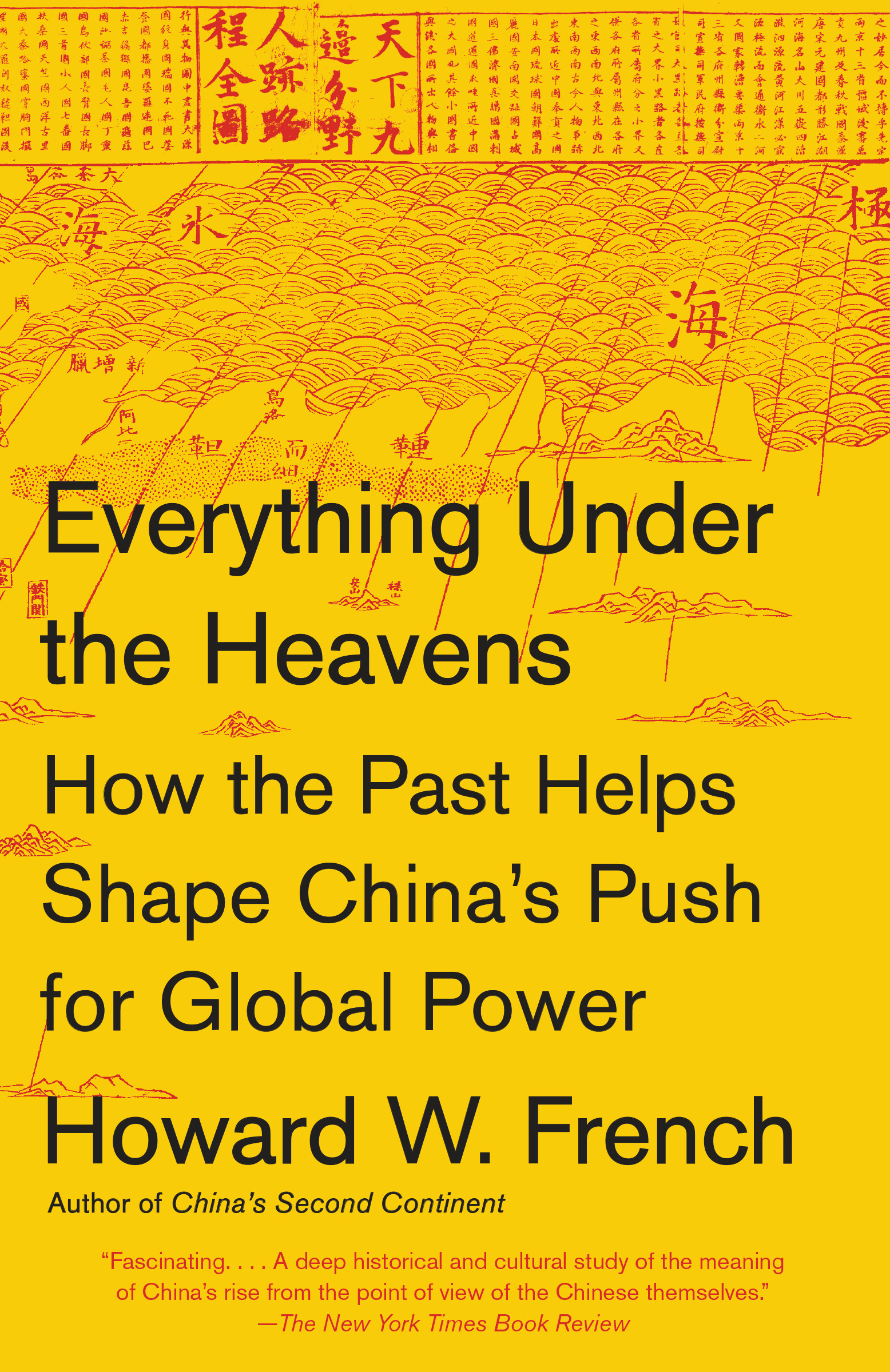
Everything Under the Heavens From the former New York Times Asia correspondent and author of China's Second Continent, an incisive investigation of China's ideological development as it becomes an ever more aggressive player in regional and global diplomacy. For many years after its reform and opening in 1978, China maintained an attitude of false modesty about its ambitions. That role, reports Howard French, has been set aside. China has asserted its place among the global heavyweights, revealing its plans for pan-Asian dominance by building its navy, increasing territorial claims to areas like the South China Sea, and diplomatically bullying smaller players. Underlying this attitude is a strain of thinking that casts China's present-day actions in decidedly historical terms, as the path to restoring the dynastic glory of the past. If we understand how that historical identity relates to current actions, in ways ideological, philosophical, and even legal, we can learn to forecast just what kind of global power China stands to become--and to interact wisely with a future peer. Steeped in deeply researched history as well as on-the-ground reporting, this is French at his revelatory best. POLITICAL SCIENCE,World,Asian
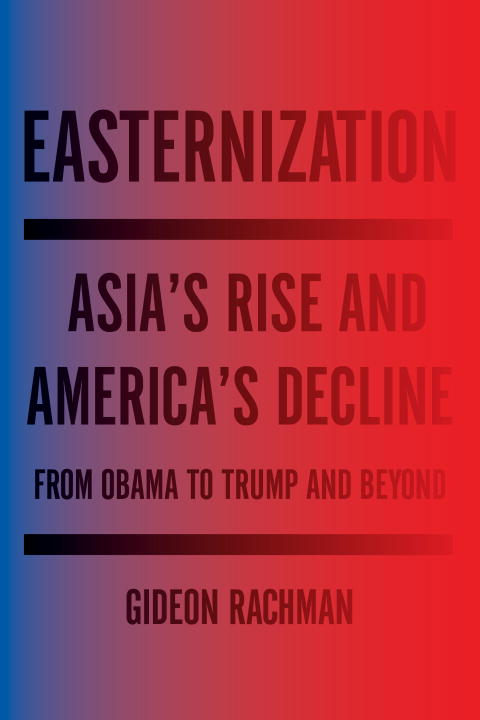
Easternization **NAMED NPR "BEST BOOKS OF 2017""** From the winner of the 2016 Orwell Prize and the European Press Prize for Commentator of the Year, a provocative analysis of how a new era of global instability has begun, as the flow of wealth and power turns from West to East. Easternization is the defining trend of our age — the growing wealth of Asian nations is transforming the international balance of power. This shift to the East is shaping the lives of people all over the world, the fate of nations, and the great questions of war and peace. A troubled but rising China is now challenging America’s supremacy, and the ambitions of other Asian powers — including Japan, North Korea, India, and Pakistan — have the potential to shake the whole world. Meanwhile the West is struggling with economic malaise and political populism, the Arab world is in turmoil, and Russia longs to reclaim its status as a great power. As it becomes clear that the West’s historic power and influence is receding, Gideon Rachman offers a road map to the turbulent process that will define the international politics of the twenty-first century. POLITICAL SCIENCE,World,Asian
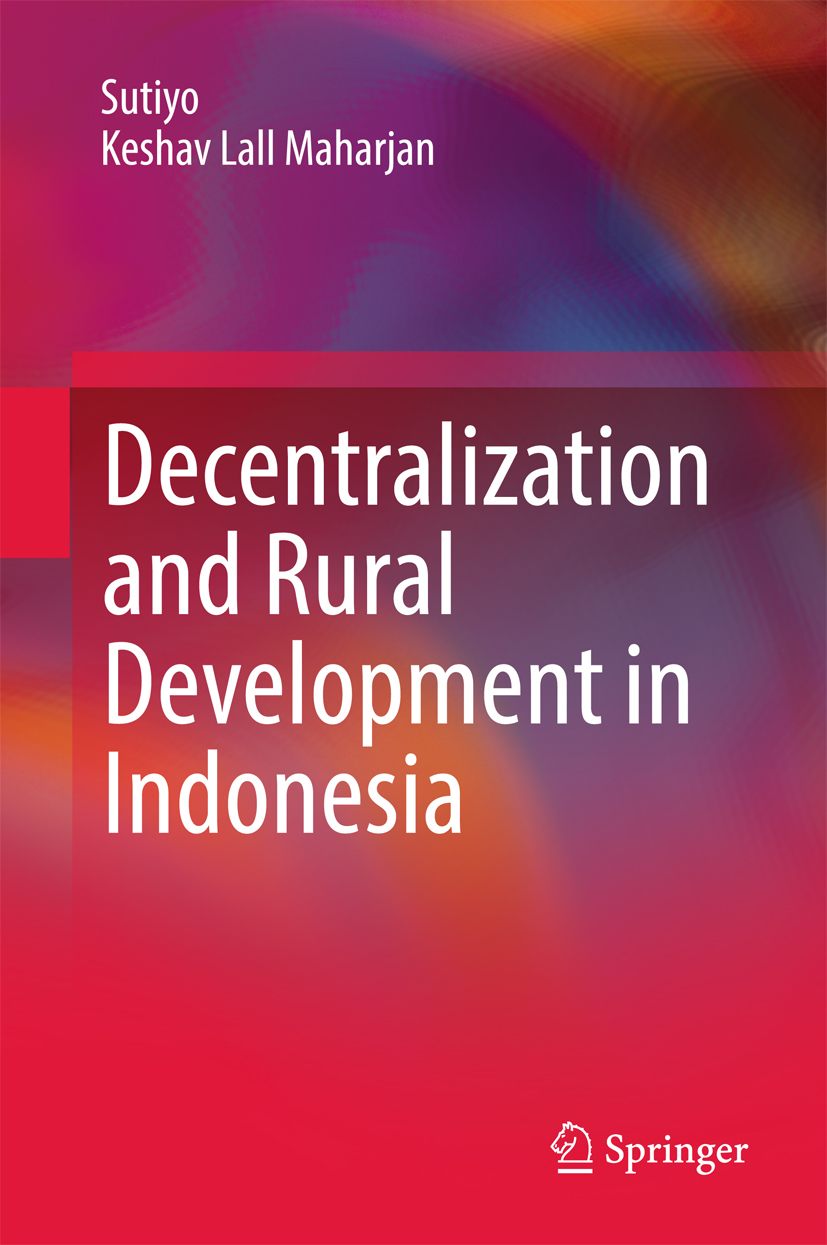
Decentralization and Rural Development in Indonesia This book integrates the fundamental theories of decentralization and rural development, providing a comprehensive explanation of how they can be successfully implemented to improve the livelihoods of rural communities in Indonesia. The topics addressed in this book include participatory budgeting, social capital, community participation, local capacity development, and poverty alleviation, which are discussed in detail from the perspectives of local politics, public administration, rural economy, and community studies. The multifaceted interrelations between these disciplines are analyzed to formulate a framework identifying the opportunities and challenges involved in formulating guiding principles for the implementation of decentralization. Readers are provided with the necessary intellectual groundwork through theoretical discussions and case studies involving grassroots realities in Indonesian villages. This book is highly recommended for all readers who are seeking an in-depth understanding of modern efforts to effectively implement decentralization in developing countries to promote local democratization, community empowerment, and poverty alleviation. POLITICAL SCIENCE,World,Asian

China's Asian Dream The latest edition of Miller’s seminal work, exploring what China’s rise means for the future of Asia, and of the world. POLITICAL SCIENCE,World,Asian
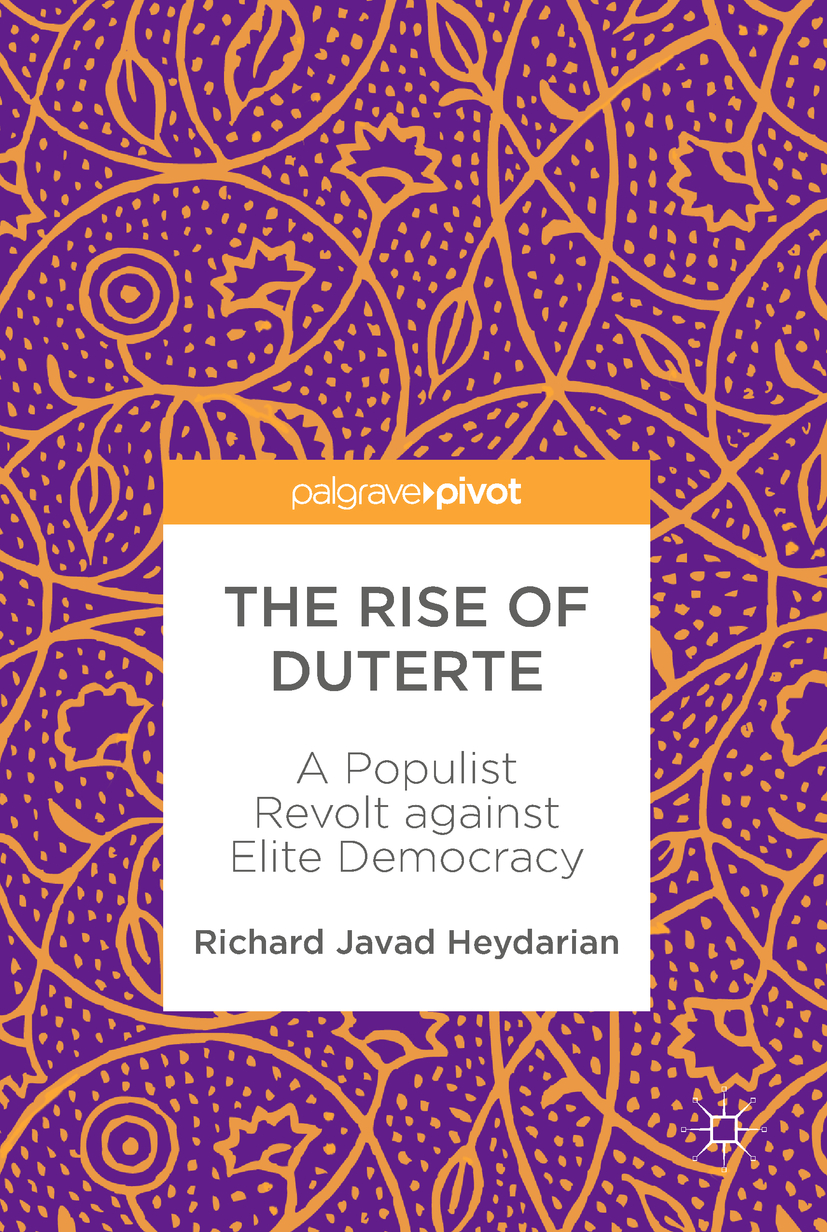
The Rise of Duterte This book draws on the extensive literature on populism, democracy, and emerging markets as well as interviews with senior government officials, experts, and journalists in the Philippines and beyond, This book is the first to analyze the significance and implications of the rise of Filipino president Rodrigo Duterte within a rapidly-changing Asia Pacific region. As China's power in the Pacific grows rapidly, nations that have traditionally been US allies, such as the Phillipines, are experiencing political convulsions; Duterte's open willingness to realign towards China (at the expense of America) in exchange for infrastructure investment is one of the clearest indicators of what China's rise might look like for nations around the world. Timely, precise, accessible and fast-paced, this book will be of value to scholars, journalists, policy-makers, and China watchers. POLITICAL SCIENCE,World,Asian

What's Your Aim, Kim Jong-un? In the Preface, Okawa writes, “It would be like a dream if the mass media in the world, including Japan, were permitted to conduct a completely exclusive interview with Kim Jong-un now. Although a spiritual coverage, this book realized over 70% of that wish.†“What’s Your Aim, Kim Jong-un?†is an English translation of a spiritual interview by Master Ryuho Okawa of Happy Science that was recorded in October 2017. It is an interview with the guardian spirit (or subconscious) of Kim Jong-un, the supreme leader of North Korea. In Japan, there are more than 450 books in the Spiritual Interview series, with over 50 of those also available in English. This time, Happy Science decided to publish this book urgently in order to inform the world of the true aim of leader Kim Jong-un which remains hidden and is one of the major factors of insecurity in the international community. Oftentimes, what is in the subconscious eventually manifests as the person’s actions in reality, so this book is likely to serve as ultra-first rate document in predicting the future events in international politics. For over 30 years, Ryuho Okawa has been conducting spiritual interviews with the spirits of great figures and well-known people who passed away in recent years. Not only that, he has also conducted such interviews with the guardian spirits, or hidden consciousnesses, of living people. Some of these spirits include Jesus Christ, Muhammad, Princess Diana, Steve Jobs and the guardian spirit of Donald Trump. The purpose of conducting spiritual interviews is to prove the existence of the Spirit World, reincarnation and guardian spirits, and to enlighten people of the truth and diversity of the Spirit World. The number and content of these books prove that spiritual messages are not fiction, but rather a real spiritual phenomenon. Quite a few Christians and materialists view spiritual messages as a heresy or doubt the credibility of the messages right from the start. It should be noted, however, that denying the newly revealed Truths, based on old religious knowledge and existing academic knowledge, is a mistake like what the churches did to Galileo—they denied heliocentric theory. Can your intellect honestly accept this spiritual Copernican Revolution in the modern age? Read Okawa’s spiritual interview series and find out… POLITICAL SCIENCE,World,Asian
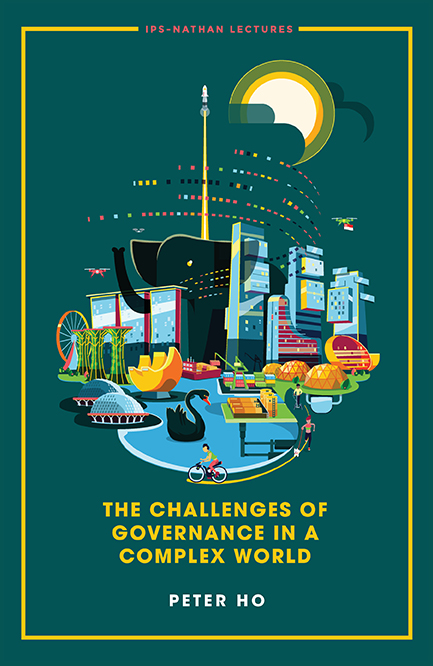
Challenges Of Governance In A Complex World, The Peter Ho, former Head of the Singapore Civil Service, was the Institute of Policy Studies' 2016/17 S R Nathan Fellow for the Study of Singapore.This book collects the four IPS-Nathan Lectures that he delivered between April and May 2017, and gathers highlights of his dialogues with the audience.Ho surveys the increasingly complex world, and suggests what governments can do to prepare for the future — even as no one can predict it. He uses metaphors such as the 'black elephant' and concepts like the 'dialectic of governance' to explain how a systematic approach to thinking about the future can help countries in general — and Singapore in particular — build resilience and develop a comparative advantage in the face of uncertainty and rapid change.The IPS-Nathan Lectures series was launched in 2014 as part of the S R Nathan Fellowship for the Study of Singapore. Its primary goal is to promote public understanding and discourse of issues of critical national interest. POLITICAL SCIENCE,World,Asian

Southeast Asia Southeast Asia: Past and Present offers a balanced and readable account of the region from ancient to modern times, covering traditional history as well as current events. D. R. SarDesai achieves a delicate balance exploring the importance of the period of European colonial rule in Southeast Asia without overemphasis as he introduces students to the regions and peoples of Myanmar, Thailand, Malaysia, Brunei, Singapore, Indonesia, East Timor, Laos, Cambodia, Vietnam, and the Philippines. Readers will find insightful introductions at the beginning of each part to aid in understanding the global and political implications of the events discussed. The seventh edition is thoroughly updated to offer coverage of current events, including the historic 2012 elections in Myanmar and Aung San Suu Kyi’s successful bid for election to the Parliament, the rise of Yingluck Shinawatra to the position of prime minister of neighboring Thailand, and the consolidation of the ASEAN and its consideration of China’s claim to the South China Sea. Combining thematic and chronological approaches with the study of colonialism, nationalism, historical and cultural heritage, and current events, Southeast Asia manages to convey an Asian point of view throughout. The second edition of Southeast Asian History: Essential Readings (978-0-8133-4857-5) is also available from D. R. SarDesai and Westview Press as a complementary or a standalone text. POLITICAL SCIENCE,World,Asian
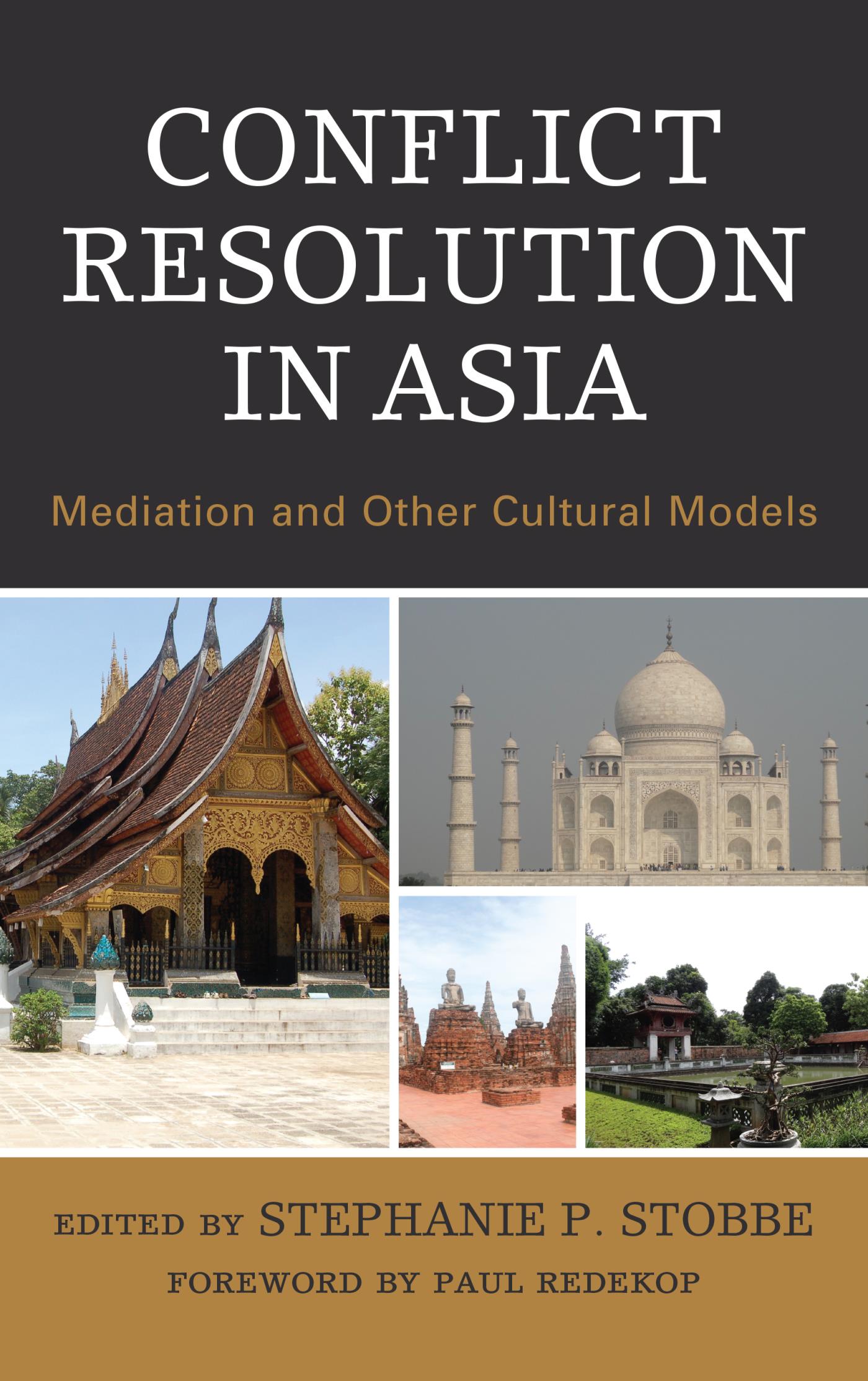
Conflict Resolution in Asia This study examines the role of mediation and other cultural conflict resolution models in Asia. The contributors use various countries as case studies to analyze how traditional, indigenous, and culturally based conflict resolution processes interact with more formal legal systems to address conflicts. POLITICAL SCIENCE,World,Asian
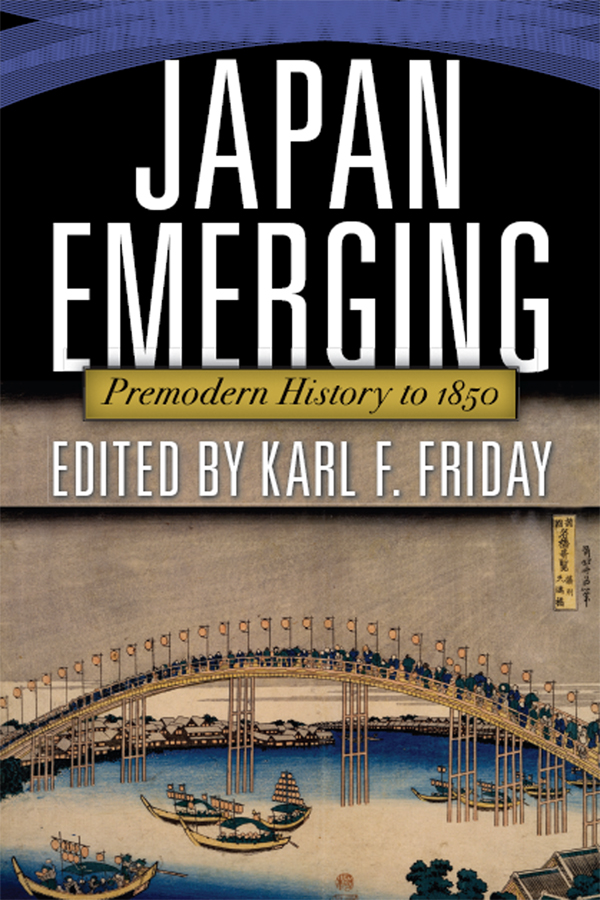
Japan Emerging Japan Emerging provides a comprehensive survey of Japan from prehistory to the nineteenth century. Incorporating the latest scholarship and methodology, leading authorities writing specifically for this volume outline and explore the main developments in Japanese life through ancient, classical, medieval, and early modern periods. Instead of relying solely on lists of dates and prominent names, the authors focus on why and how Japanese political, social, economic, and intellectual life evolved. Each part begins with a timeline and a set of guiding questions and issues to help orient readers and enhance continuity. Engaging, thorough, and accessible, this is an essential text for all students and scholars of Japanese history. POLITICAL SCIENCE,World,Asian
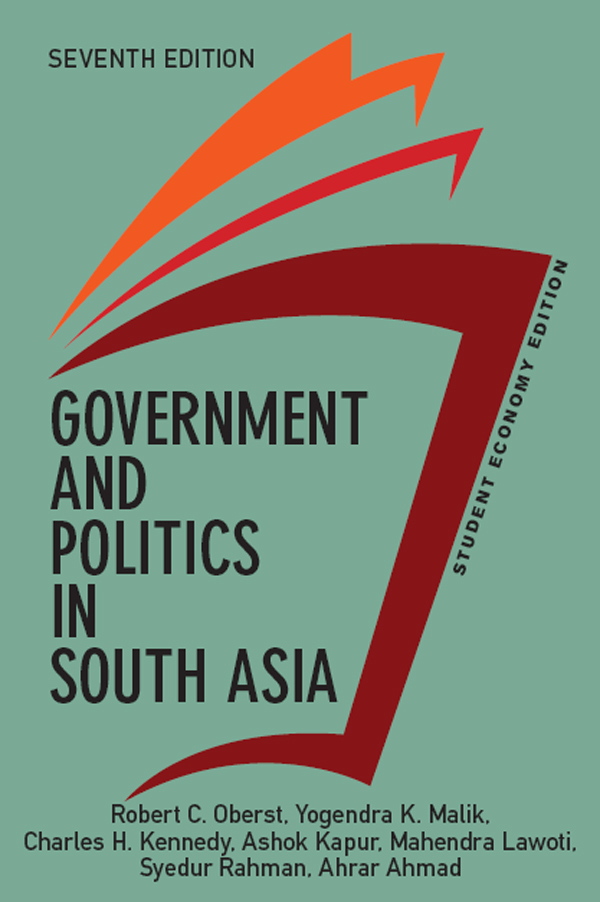
Government and Politics in South Asia, Student Economy Edition This book describes the countries of South Asia, and examines the reason for their successes and failures. It addresses the interrelationships among the states in the region and their roles in the international system, and discusses the political development of the region. POLITICAL SCIENCE,World,Asian
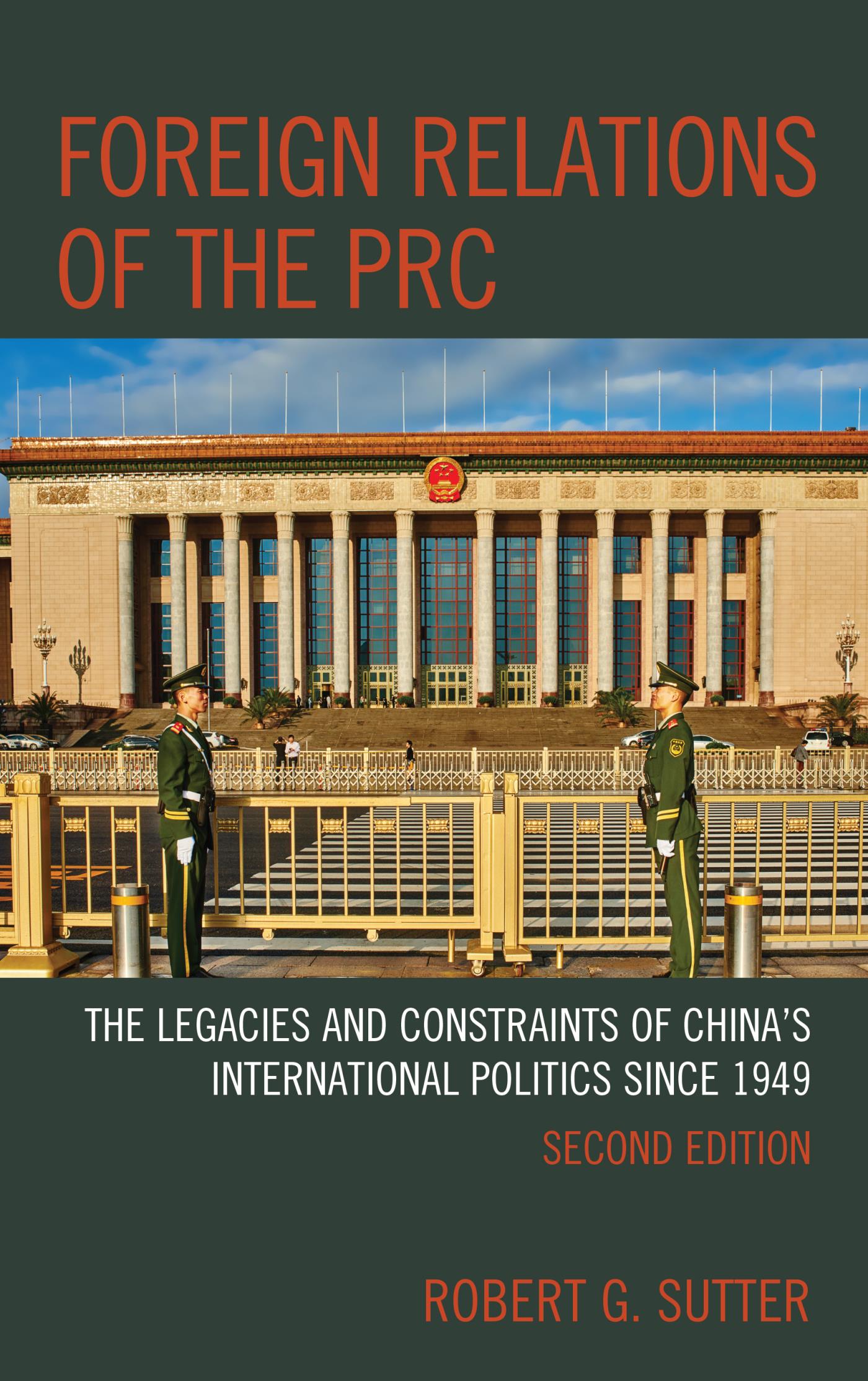
Foreign Relations of the PRC Now in a fully updated edition, this cogent book examines the international relations of the PRC since its founding in 1949. Sutter provides a balanced assessment of the country’s recent successes and advances as well as the legacies and constraints that hamper it, especially in nearby Asia—long the focus of China’s foreign policy attention. POLITICAL SCIENCE,World,Asian
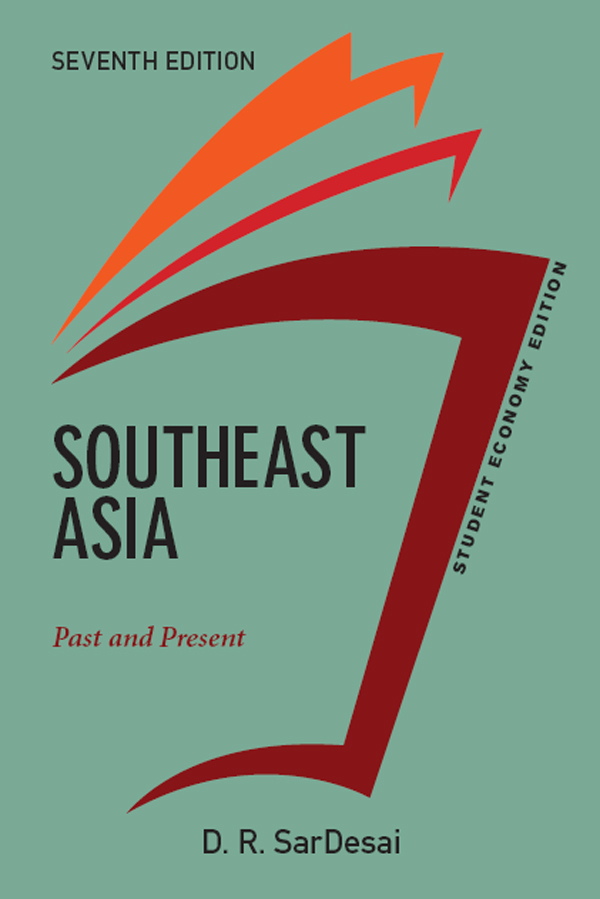
Southeast Asia, Student Economy Edition This book is concerned with Western activity in the southeast Asia and the indigenous reaction to it. It deals with the traditions of the people of Southeast Asia, traditions that, apply to both urban and rural populations. The book includes the early European intrusion in insular Southeast Asia. POLITICAL SCIENCE,World,Asian
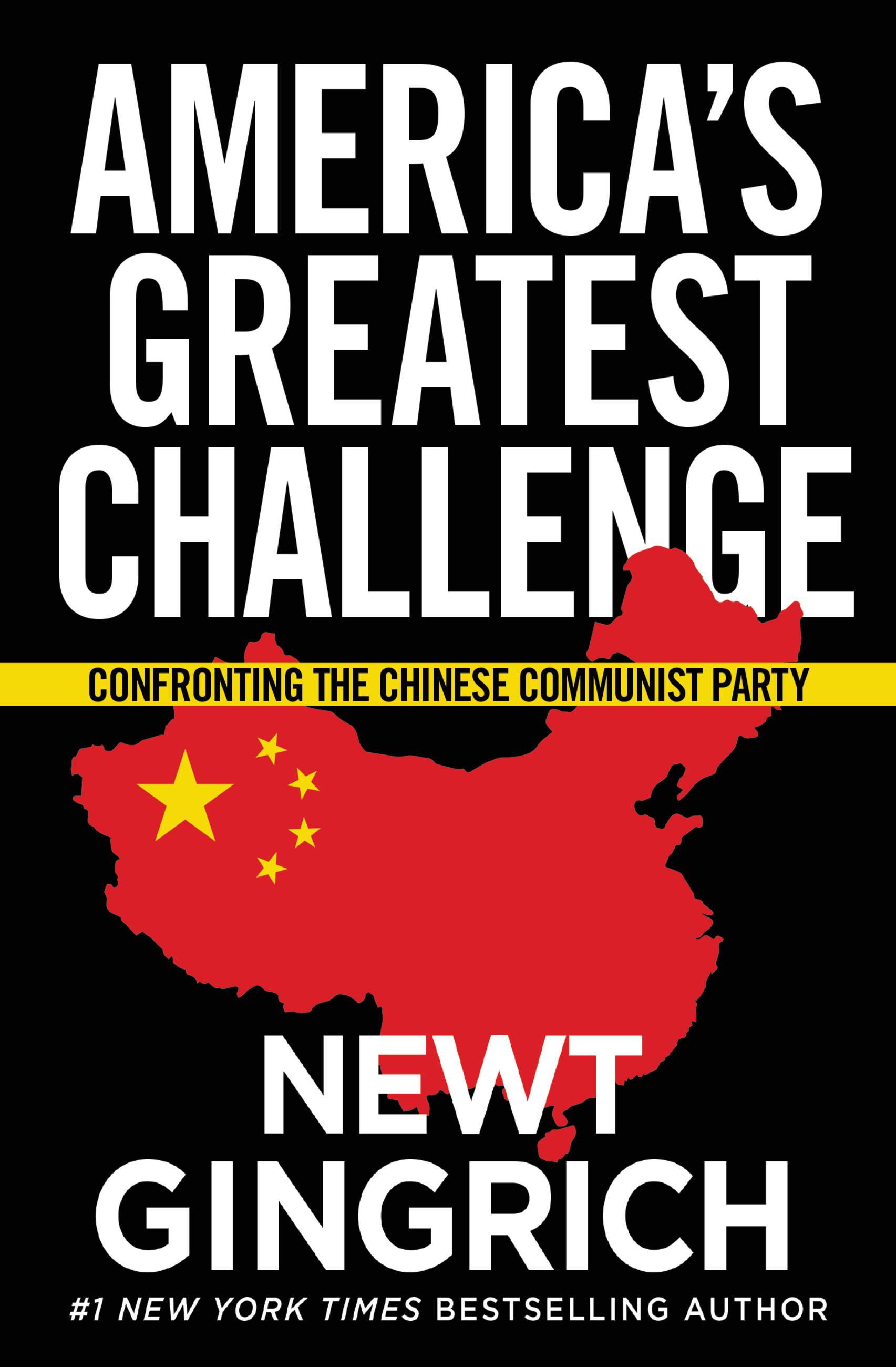
Trump vs. China Former Speaker of the House Newt Gingrich sounds the warning bell that communist-ruled China poses the biggest threat to the United States that we have seen in our lifetime. The United States is currently engaged in a competition with the Chinese government unlike any other that we have witnessed before. This is a competition between the American system -- which is governed by freedom and the rule of law -- and a totalitarian dictatorship that is controlled by the Chinese Communist Party. These are two different visions for the future; one will succeed, and one will fail. It is possible for America to respond to the Chinese Communist Party's efforts, but doing so will require new thinking, many big changes, and many hard choices for our leaders in government and private sector. Newt Gingrich's Trump vs. China serves as a rallying cry for the American people and a plan of action for our leaders in government and the private sector. Written in a language that every American can understand but still rich in detail and accurate in fact, Trump vs. China exposes the Chinese Communist Party's multi-pronged threat against the United States and what we must do as a country to survive. POLITICAL SCIENCE,World,Asian

The Hermit King North Korea is poised at the crossroads of history. Which direction will its leader take? Throughout the world, oppressive regimes are being uprooted and replaced by budding democracies, but one exception remains: The People's Republic of North Korea. The Kim family has clung to power for three generations by silencing dissidents, ruling with an iron fist, and holding its neighbors hostage with threats of war. Under the leadership of Kim Jong Un, North Korea has come closer than ever to creating a viable nuclear arsenal, but widespread famine and growing resistance are weakening his regime's stability. In The Hermit King, Asian geopolitical expert Chung Min Lee tells the story of the rise of the Kim Dynasty and its atrocities, motivations, and diplomatic goals. He also discusses the possible outcomes of its aggressive standoff with the world superpowers. Kim Jong Un is not a crazed "Rocket Man" or a bumbling despot; he has been groomed since birth to take control of his country and stay in power at all costs. He is now at a fateful crossroads. Will he make good on decades of threats, liberalize North Korea and gain international legitimacy, or watch his regime crumble around him? Lee analyzes the likelihood and consequences of each of these possibilities, cautioning that in the end, a humanitarian crisis in the region is all but unavoidable. The Hermit King is a thoughtful and compelling look at the most complicated diplomatic situation on Earth. POLITICAL SCIENCE,World,Asian
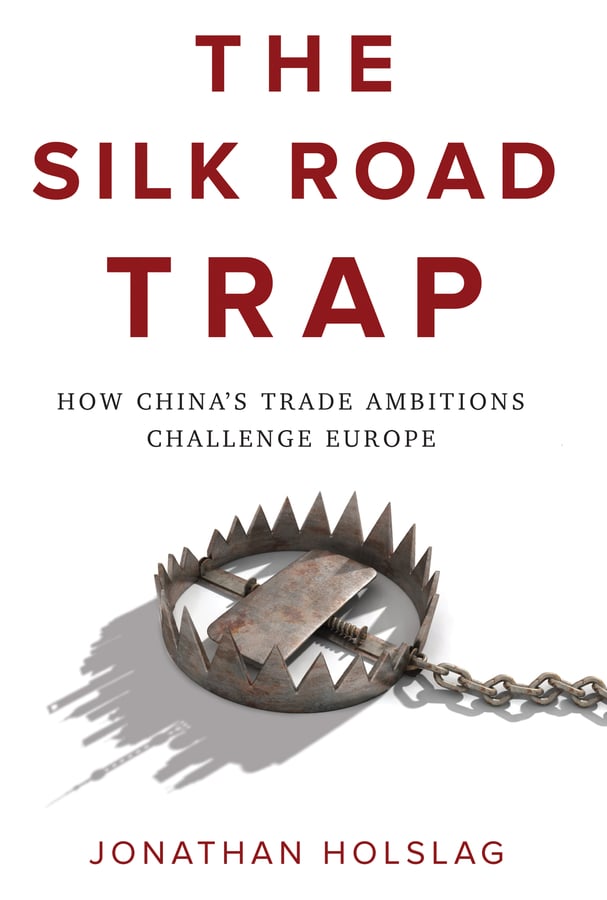
The Silk Road Trap For almost two decades, China has claimed that its expanding economy benefits Europe, stimulating European growth, exports, and employment. But the reality is not so clear-cut. Whilst individual companies may have profited from China’s economic rise,unbalanced trade with China has actually cost Europe over 1.4 trillion euros in the last ten years as well as undermining its political influence. China’s monumental infrastructural project, the Belt And Road Initiative or New Silk Road as it has come to be known - is set to make this situation even worse. The Silk Road Trap is the first book to expose just how risky this uneven partnership is for Europe. In it, leading expert on Asian affairs Jonathan Holslag, argues that Europe must reduce its reliance on China and work on building a stronger and more sustainable European economic model. By revealing the political aspirations and economic strategy behind the new Silk Road, he lays out its implications for specific European industries, from steel over aircraft to robots. Holslag, though critical of China, does not, however, make the case for confrontational, Trumpian protectionism. Instead, he posits that the new Silk Road need not ensnare Europe; it offers the continent a unique opportunity to transition from a future "made in China" to one that is "made in Europe". POLITICAL SCIENCE,World,Asian

The State and Politics In Japan Politics in Japan is undergoing a major transformation. Under the leadership of Prime Minister Abe Shinzo, the ruling Liberal Democratic Party has, since 2012, embarked upon an ambitious programme of policy reforms as well as changes to Japan’s governing structures and processes. At the heart of this policy agenda is ‘Abenomics’ – a set of measures designed to boost Japan’s flagging economy, but one which is yet to deliver on its promises. In this fully revised and updated second edition of his classic text, Ian Neary explores the dynamics of democracy in Japan, introducing the key institutions, developments and actors in its politics from the end of the Second World War to the present day. Packed with illustrative material and examples, this comprehensive study traces the continuities and the changes that are underway in five major policy areas: foreign and defence, industry, social welfare, the environment and human rights. Assuming no prior knowledge of Japan, this textbook will be an invaluable and welcome resource for all students interested in the government and politics of contemporary Japan and its international profile. POLITICAL SCIENCE,World,Asian
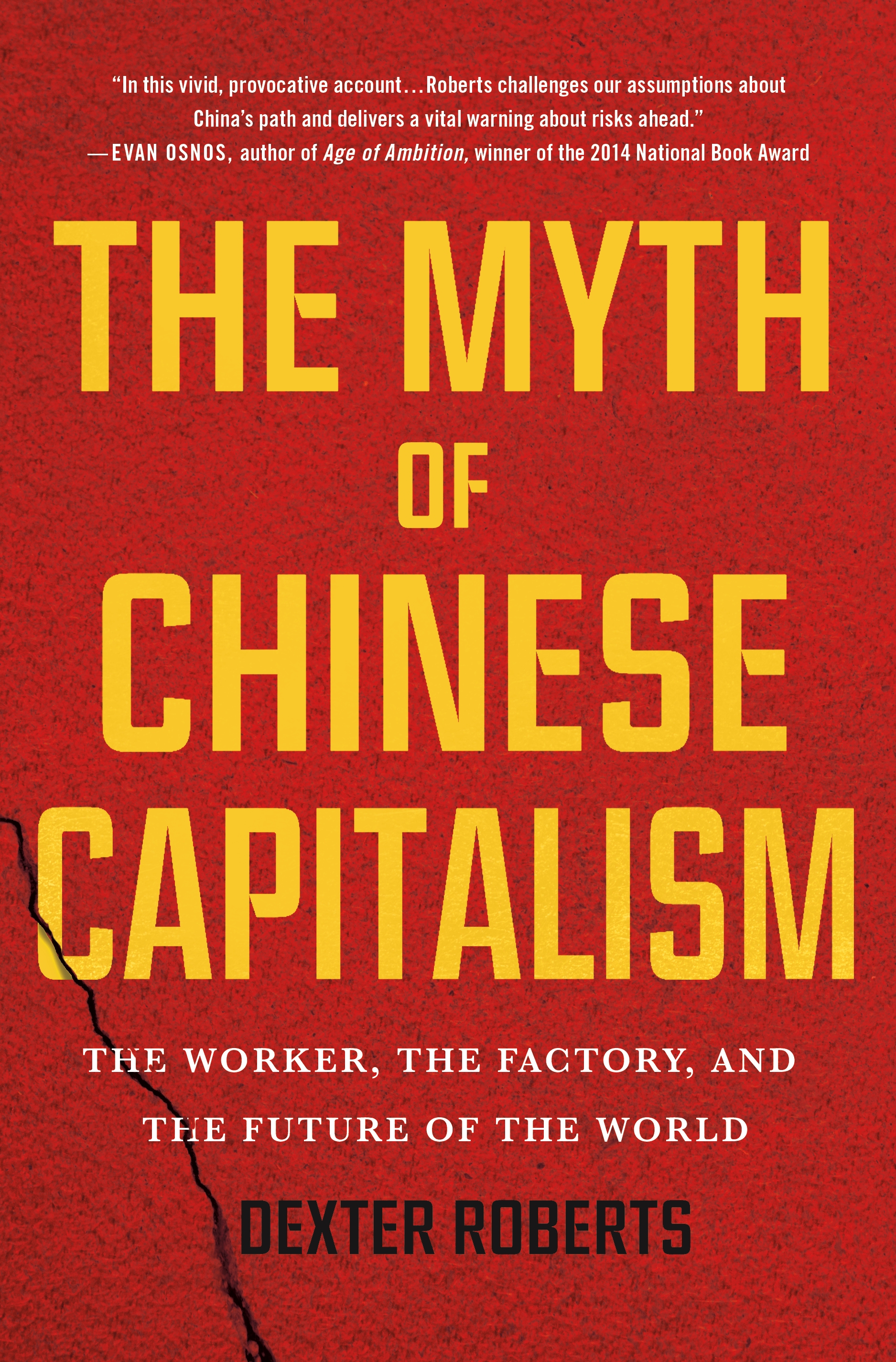
The Myth of Chinese Capitalism The untold story of how restrictive policies are preventing China from becoming the world’s largest economy Dexter Roberts lived in Beijing for two decades working as a reporter on economics, business and politics for Bloomberg Businessweek. In The Myth of Chinese Capitalism, Roberts explores the reality behind today’s financially-ascendant China and pulls the curtain back on how the Chinese manufacturing machine is actually powered. He focuses on two places: the village of Binghuacun in the province of Guizhou, one of China’s poorest regions that sends the highest proportion of its youth away to become migrants; and Dongguan, China’s most infamous factory town located in Guangdong, home to both the largest number of migrant workers and the country’s biggest manufacturing base. Within these two towns and the people that move between them, Roberts focuses on the story of the Mo family, former farmers-turned-migrant-workers who are struggling to make a living in a fast-changing country that relegates one-half of its people to second-class status via household registration, land tenure policies and inequality in education and health care systems. In The Myth of Chinese Capitalism, Dexter Roberts brings to life the problems that China and its people face today as they attempt to overcome a divisive system that poses a serious challenge to the country’s future development. In so doing, Roberts paints a boot-on-the-ground cautionary picture of China for a world now held in its financial thrall. Dexter Roberts is an award-winning journalist and a regular commentator on the U.S.-China trade and political relationship. His prior speaking engagements include traditional news media outlets (NPR, Fox News, CNN International) as well as universities and institutes (George Washington University, Council on Foreign Relations, and the Overseas Press Club). He is available for virtual classroom visits to courses that adopt The Myth of Chinese Capitalism. Please contact academic@macmillan.com for more information. POLITICAL SCIENCE,World,Asian
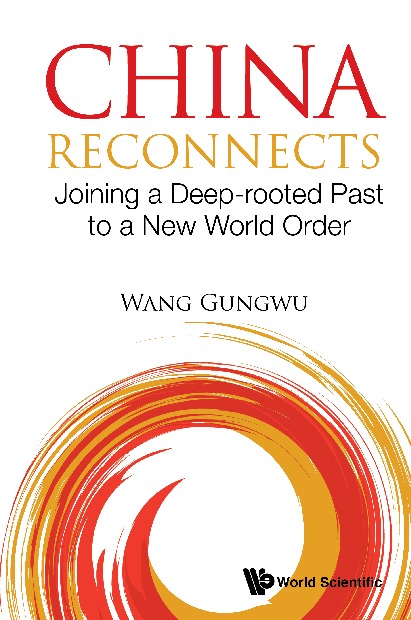
China Reconnects The book shows how the Chinese are now confident of their capacity to learn all they need from the developed world and are keen to know which parts of the past they would need to build a modern Chinese civilization. They are very conscious of the challenges coming from the United States, and are looking for ways and means to respond to a superpower that wants to preserve its dominant position in the international status quo.The book seeks to explain what China is doing and what its immediate and long-term interests are. It is not to defend or judge China. It does not employ theoretical frameworks that are not appropriate for describing Chinese conditions. It calls for understanding why history is particularly relevant to the Chinese state and most of its people. That way, we also see how the present and hopes for the future changes our perspectives of the past. Related Link(s) POLITICAL SCIENCE,World,Asian
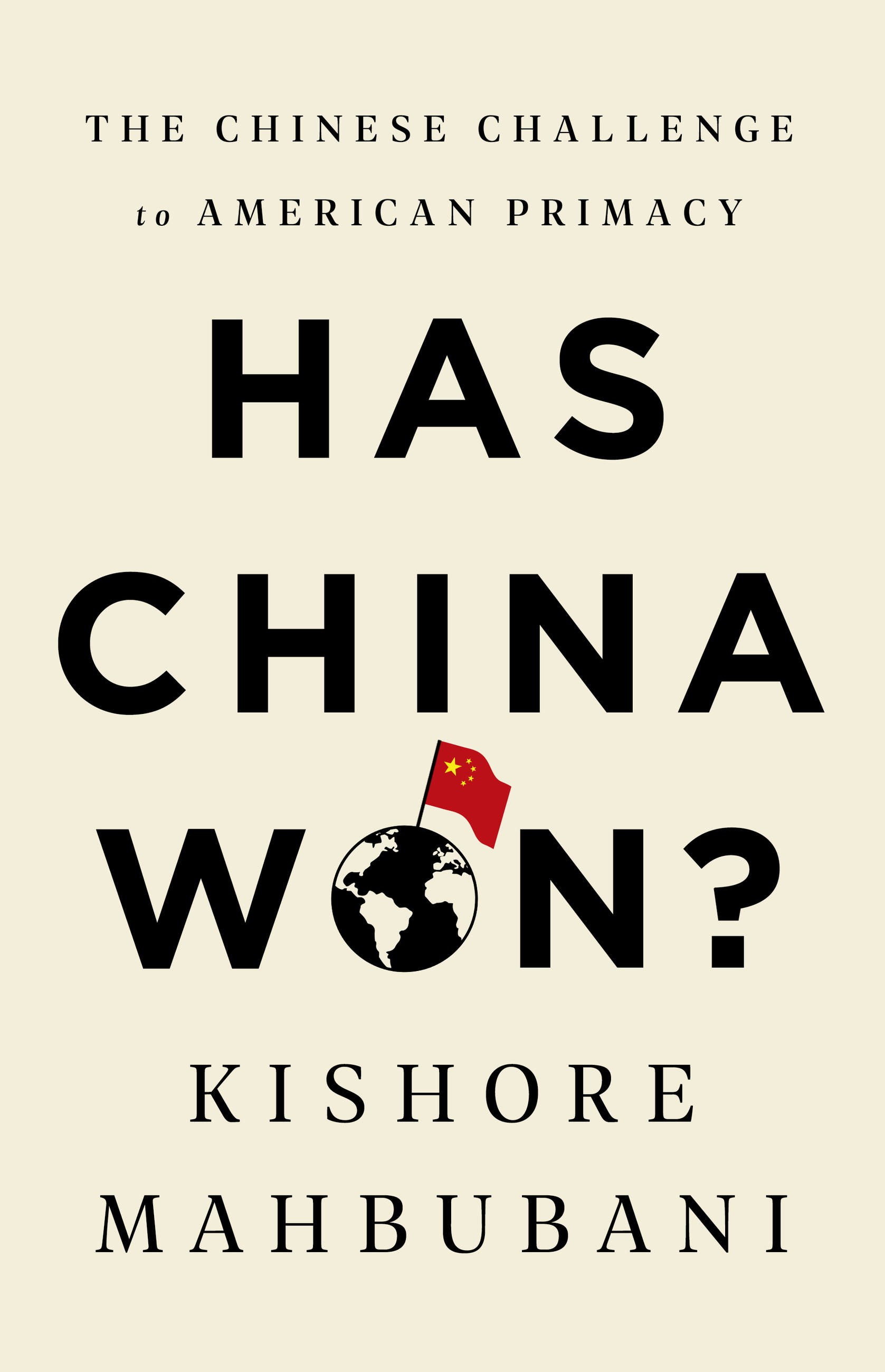
Has China Won? The defining geopolitical contest of the twenty-first century is between China and the US. But is it avoidable? And if it happens, is the outcome already inevitable? China and America are world powers without serious rivals. They eye each other warily across the Pacific; they communicate poorly; there seems little natural empathy. A massive geopolitical contest has begun. America prizes freedom; China values freedom from chaos. America values strategic decisiveness; China values patience. America is becoming society of lasting inequality; China a meritocracy. America has abandoned multilateralism; China welcomes it. Kishore Mahbubani, a diplomat and scholar with unrivalled access to policymakers in Beijing and Washington, has written the definitive guide to the deep fault lines in the relationship, a clear-eyed assessment of the risk of any confrontation, and a bracingly honest appraisal of the strengths and weaknesses, and superpower eccentricities, of the US and China. POLITICAL SCIENCE,World,Asian

The European Union and China An up-to-date and accessible introduction to EU-China relations. It explores the key aspects of the relationship - trade and the economy, security and human rights, development and culture - and places it in the broader context of both of their roles on the world stage. POLITICAL SCIENCE,World,Asian
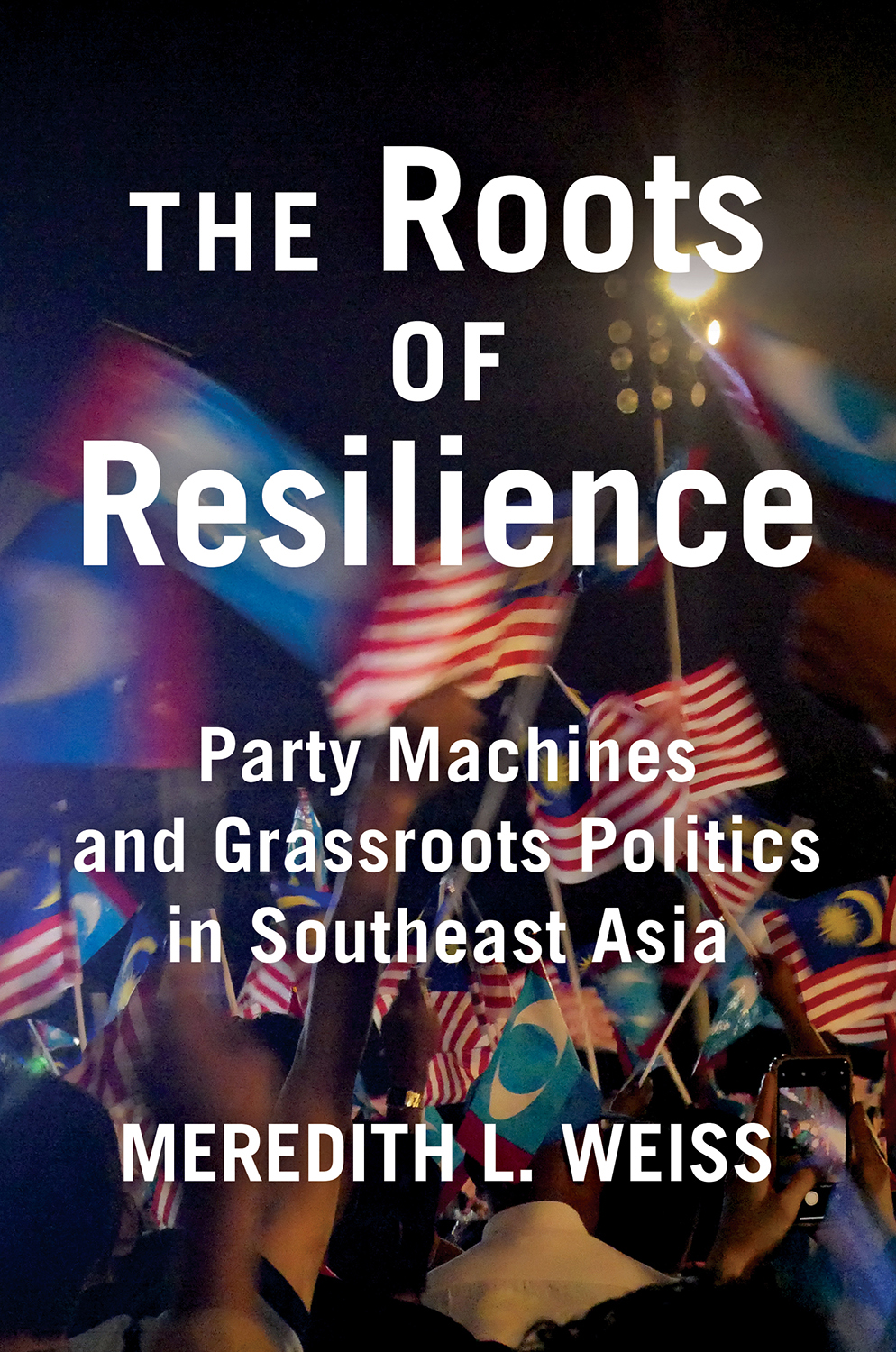
The Roots of Resilience The Roots of Resilience examines governance from the ground up in the world's two most enduring electoral authoritarian or "hybrid" regimes—Singapore and Malaysia—where politically liberal and authoritarian features are blended to evade substantive democracy. Although skewed elections, curbed civil liberties, and a dose of coercion help sustain these regimes, selectively structured state policies and patronage, partisan machines that effectively stand in for local governments, and diligently sustained clientelist relations between politicians and constituents are equally important. While key attributes of these regimes differ, affecting the scope, character, and balance among national parties and policies, local machines, and personalized linkages—and notwithstanding a momentous change of government in Malaysia in 2018—the similarity in the overall patterns in these countries confirms the salience of these dimensions. As Meredith L. Weiss shows, taken together, these attributes accustom citizens to the system in place, making meaningful change in how electoral mobilization and policymaking happen all the harder to change. This authoritarian acculturation is key to the durability of both regimes, but, given weaker party competition and party–civil society links, is stronger in Singapore than Malaysia. High levels of authoritarian acculturation, amplifying the political payoffs of what parties and politicians actually provide their constituents, explain why electoral turnover alone is insufficient for real regime change in either state. POLITICAL SCIENCE,World,Asian
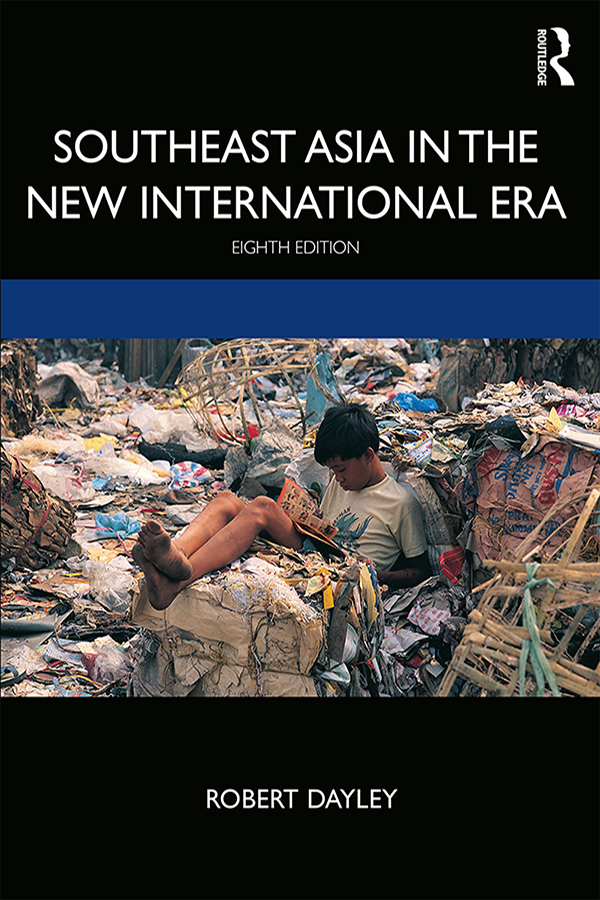
Southeast Asia in the New International Era This newly revised eighth edition of Southeast Asia in the New International Era provides readers with contemporary coverage of a vibrant region home to more than 650 million people, vast cultural diversity, and dynamic globalized markets. Sensitive to historical legacies and paying special attention to developments since the end of the Cold War, this book highlights the events, players, and institutions that shape the region. Employing a country-by-country format, the analysis engages in context-specific treatment of the region's eleven countries: Thailand, Myanmar (Burma), Vietnam, Cambodia, Laos, the Philippines, Indonesia, Timor-Leste, Malaysia, Singapore, and Brunei. Fully updated, the book’s revised content includes Rodrigo Duterte’s drug war in the Philippines, Malaysia’s historic 2018 election ending four decades of UMNO rule, Hun Sen’s latest power grab in Cambodia, and a consequential monarchical transition in post-coup Thailand. It also analyzes recent developments in the South China Sea dispute, the Rohingya tragedy in Myanmar, China’s expanding Belt and Road Initiative, as well as the effects of the Trump Administration’s tariffs and trade war. An excellent resource for students, this textbook makes sense of the region's coups, elections, policy debates, protests, and alliances, leaving readers with a solid foundation for further study. POLITICAL SCIENCE,World,Asian
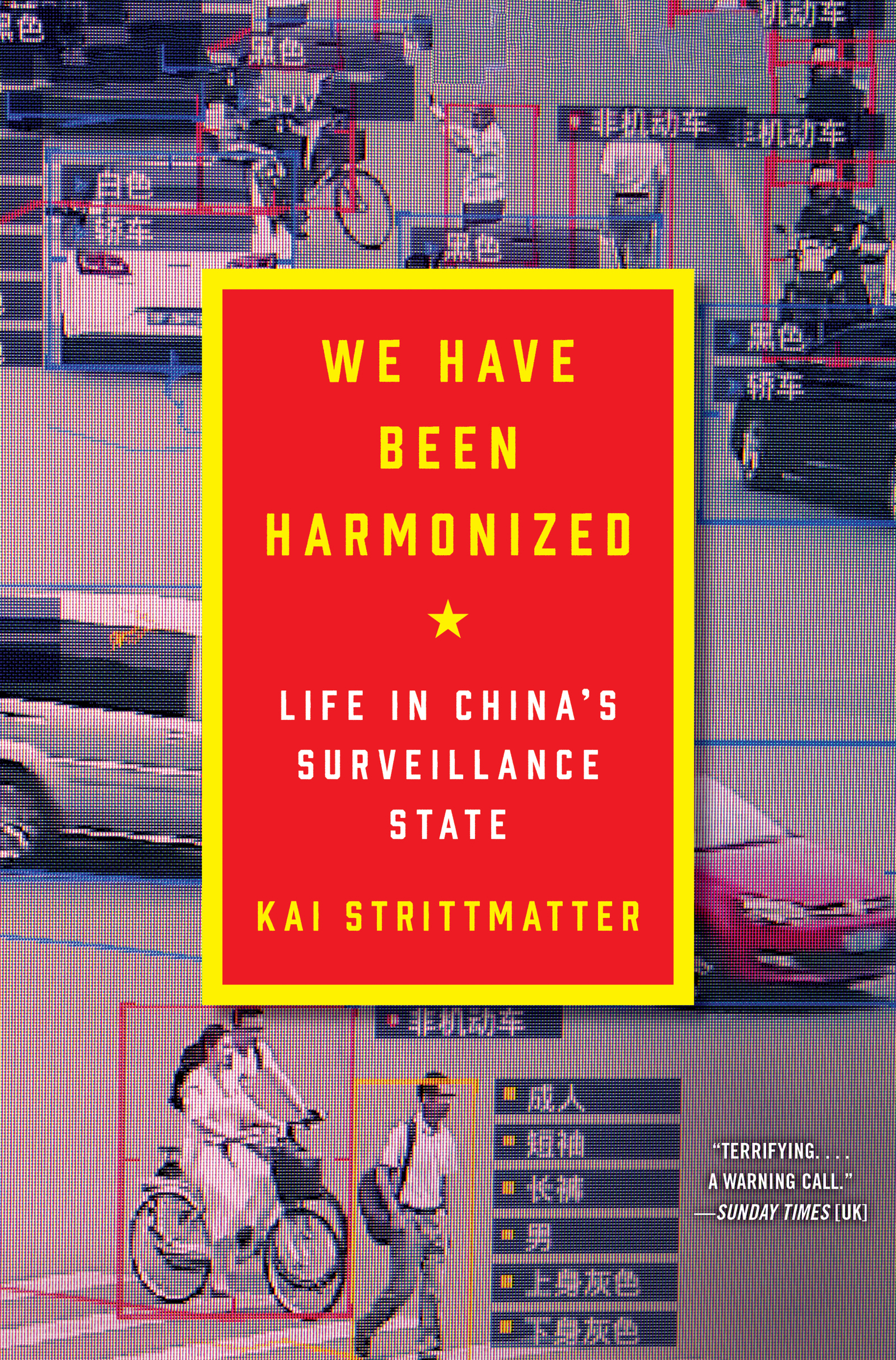
We Have Been Harmonized “A remarkable book. … The more one reads, the more pressing one conclusion becomes: almost everything we thought we knew about contemporary China is wrong.†— The Observer, “Book of the Week†Hailed as a masterwork of reporting and analysis, and based on decades of research within China, We Have Been Harmonized, by award-winning correspondent Kai Strittmatter, offers a groundbreaking look at how the interÂnet and high tech have allowed China to create the largest and most effective surveillance state in history. China’s new drive for repression is being underpinned by unpreÂcedented advances in technology: facial and voice recognition, GPS tracking, supercomputer databases, intercepted cell phone converÂsations, the monitoring of app use, and millions of high-resolution security cameras make it nearly impossible for a Chinese citizen to hide anything from authorities. Commercial transactions, including food deliveries and online purchases, are fed into vast databases, along with everything from biometric information to social media activities to methods of birth control. Cameras (so advanced that they can locate a single person within a stadium crowd of 60,000) scan for faces and walking patterns to track each individual’s moveÂment. In some schools, children’s facial expressions are monitored to make sure they are paying attention at the right times. In a new Social Credit System, each citizen is given a score for good behavior; for those who rate poorly, punishments include being banned from flying or taking high-speed trains, exclusion from certain jobs, and preventing their children from attending better schools. And it gets worse: advanced surveillance has led to the imprisonment of more than a million Chinese citizens in western China alone, many held in draconian “reeducation†camps. This digital totalitarianism has been made possible not only with the help of Chinese private tech companies, but the complicÂity of Western governments and corporations eager to gain access to China’s huge market. And while governments debate trade wars and tariffs, the Chinese Communist Party and its local partners are aggressively stepping up their efforts to export their surveillance technology abroad—including to the United States. We Have Been Harmonized is a terrifying portrait of life under unprecedented government surveillance—and a dire warning about what could happen anywhere under the pretense of national security. “Terrifying. … A warning call." —The Sunday Times (UK), a “Best Book of the Year so Far†POLITICAL SCIENCE,World,Asian

The Great U.S.-China Tech War The United States and China are locked in a “cold tech war,†and the winner will end up dominating the twenty-first century. Beijing was not considered a tech contender a decade ago. Now, some call it a leader. America is already behind in critical areas. It is no surprise how Chinese leaders made their regime a tech powerhouse. They first developed and then implemented multiyear plans and projects, adopting a determined, methodical, and disciplined approach. As a result, China’s political leaders and their army of technocrats could soon possess the technologies of tomorrow. America can still catch up. Unfortunately, Americans, focused on other matters, are not meeting the challenges China presents. A whole-of-society mobilization will be necessary for the U.S. to regain what it once had: control of cutting-edge technologies. This is how America got to the moon, and this is the key to winning this century. Americans may not like the fact that they’re once again in a Cold War–type struggle, but they will either adjust to that reality or get left behind. POLITICAL SCIENCE,World,Asian

Asia's New Geopolitics The Indo-Pacific is fast becoming the world's dominant region. Now, as it grows in power and wealth, geopolitical competition has reemerged, threatening future stability not merely in Asia but around the globe. China is aggressive and uncooperative, and increasingly expects the world to bend to its wishes. The focus on Sino-US competition for global power has obscured “Asia's other great game”: the rivalry between Japan and China. A modernizing India risks missing out on the energies and talents of millions of its women, potentially hampering the broader role it can play in the world. And in North Korea, the most frightening question raised by Kim Jong-un's pursuit of the ultimate weapon is also the simplest: Can he control his nukes? In Asia's New Geopolitics: Essays on Reshaping the Indo-Pacific, Michael R. Auslin examines these and other key issues transforming the Indo-Pacific and the broader world. He also explores the history of American strategy in Asia, from the 18th century through today. Taken together, Auslin's essays convey the richness and diversity of the region: with more than three billion people, the Indo-Pacific contains over half of the global population, including the world's two most populous nations, India and China. In a riveting final chapter, Auslin imagines a war between America and China in a bid for regional hegemony and what this conflict might look like. POLITICAL SCIENCE,World,Asian

Fluid Jurisdictions This wide-ranging, geographically ambitious book tells the story of the Arab diaspora within the context of British and Dutch colonialism, unpacking the community's ambiguous embrace of European colonial authority in Southeast Asia. In Fluid Jurisdictions, Nurfadzilah Yahaya looks at colonial legal infrastructure and discusses how it impacted, and was impacted by, Islam and ethnicity. But more important, she follows the actors who used this framework to advance their particular interests. Yahaya explains why Arab minorities in the region helped to fuel the entrenchment of European colonial legalities: their itinerant lives made institutional records necessary. Securely stored in centralized repositories, such records could be presented as evidence in legal disputes. To ensure accountability down the line, Arab merchants valued notarial attestation land deeds, inheritance papers, and marriage certificates by recognized state officials. Colonial subjects continually played one jurisdiction against another, sometimes preferring that colonial legal authorities administer Islamic law—even against fellow Muslims. Fluid Jurisdictions draws on lively material from multiple international archives to demonstrate the interplay between colonial projections of order and their realities, Arab navigation of legally plural systems in Southeast Asia and beyond, and the fraught and deeply human struggles that played out between family, religious, contract, and commercial legal orders. POLITICAL SCIENCE,World,Asian
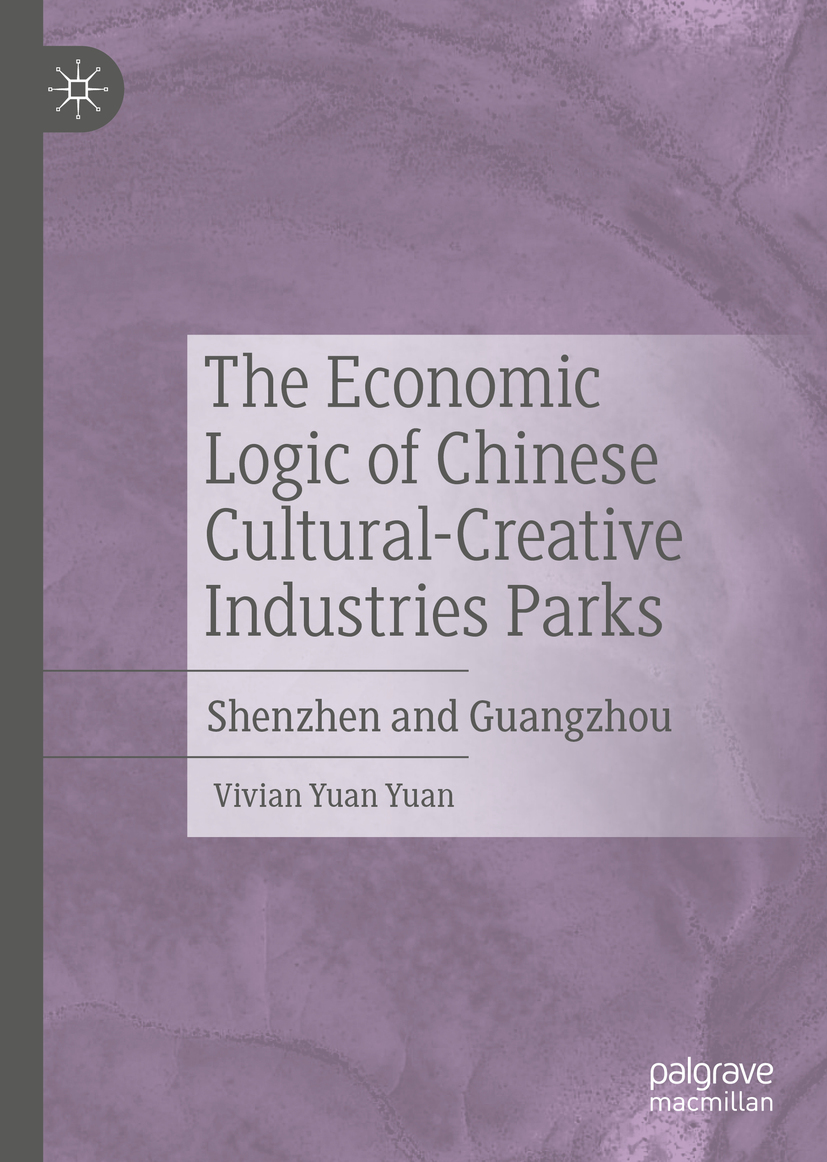
The Economic Logic of Chinese Cultural-Creative Industries Parks This book is a novel and inspiring research work on creative industry clusters in China. Seldom has literature on CCIPs dealt with the detailed economic logic and operational methods of a CCIP. The author not only does a detailed comparison of two business models of Cultural-Creative Industries Parks (CCIPs) using classic qualitative methodology through two case studies, Shenzhen OCT-LOFT as a “Culture Highland†model and Guangzhou 289 Art Park as a “Modular System†model, but also proposes a practical 4C model as the business framework for CCIPs. This book will be of interest to urbanists, scholars of the culture economy, creative industries and China scholars. POLITICAL SCIENCE,World,Asian

A World Transformed The book describes the currently precarious state of an emerging multipolar world at the time of the peaceful rise of China. POLITICAL SCIENCE,World,Asian

Japan’s Nuclear Identity and Its Implications for Nuclear Abolition This book examines Japan’s nuclear identity and its implications for abolition of nuclear weapons. By applying analytical eclecticism in combination with international relations theory, this book categorizes Japan’s nuclear identity as a ‘nuclear-bombed state’ (classical liberalism), ‘nuclear disarmament state’ (neoliberalism), ‘nuclear-threatened state’ (classical realism), and a ‘nuclear umbrella state’ (neorealism). This research investigates whether the bombings of Hiroshima and Nagasaki were ‘genocide’ or not, to what degree Japan has contributed to nuclear disarmament, how Japan has been threatened by ballistic missiles and nuclear weapons of North Korea, and how Japan’s security policy has been embedded with the nuclear strategy of the United States. It also sheds light on theoretical factors that Japan does not support the Treaty on Prohibition of Nuclear Weapons (TPNW). Finally, this book considers the future of Japan’s nuclear identity and attempts to explore alternatives for Japan’s nuclear disarmament diplomacy toward a world without nuclear weapons. POLITICAL SCIENCE,World,Asian

Transition beyond Denuclearisation This book seeks to go beyond conventional literature on the North Korean nuclear issue by examining the chances of survival of the Kim Jong Un regime, both with and without the nuclear weapons program. It offers a detailed historical background of the dysfunctional North Korean economy, explores the contemporary socioeconomic condition of the country, examines the failures of the Six-party Talks and other attempts at negotiations with North Korea, and outlines a blueprint for the survival of the regime through rapid economic modernization to be put forward by the five stakeholder nations in exchange for dismantlement of the nuclear weapons program. POLITICAL SCIENCE,World,Asian

Uneasy Military Encounters Uneasy Military Encounters presents a historically and theoretically grounded political ethnography of the Thai military's counterinsurgency practices in the southern borderland, home to the greater part of the Malay-Muslim minority. Ruth Streicher argues that counterinsurgency practices mark the southern population as the racialized, religious, and gendered other of the Thai, which contributes to producing Thailand as an imperial formation: a state formation based on essentialized difference between the Thai and their others. Through a genealogical approach, Uneasy Military Encounters addresses broad conceptual questions of imperial politics in a non-Western context: How can we understand imperial policing in a country that was never colonized? How is "Islam" constructed in a state that is officially secular and promotes Buddhist tolerance? What are the (historical) dynamics of imperial patriarchy in a context internationally known for its gender pluralism? The resulting ethnography excavates the imperial politics of concrete encounters between the military and the southern population in the ongoing conflict in southern Thailand. POLITICAL SCIENCE,World,Asian
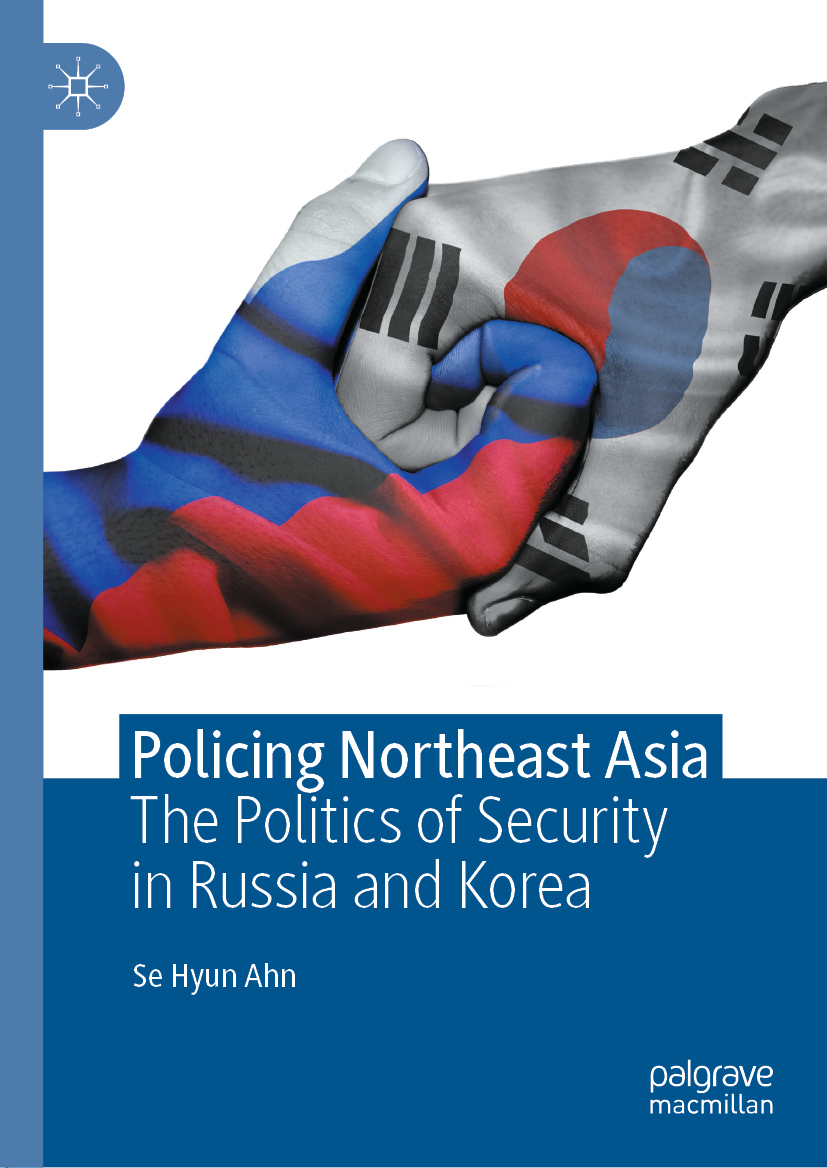
Policing Northeast Asia This book explores the progress in and the obstacles surrounding developing comprehensive security cooperation between Russia and South Korea since diplomatic relations were established in 1991 within the framework of economic security. The book focuses on oil and natural gas projects, linking the Trans-Siberian and Trans-Korean Railroads, industrial development in the Nakhodka Free Economic Zone, fishery cooperation, and the arms trade, and examines whether these five aspects of cooperation serve to contribute to building Russian-South Korean bilateral and regional economic security. The author argues that these five aspects of cooperation all have the potential to enhance comprehensive bilateral security and further regional economic security in Northeast Asia. However, Russian-South Korean economic cooperation has been hampered by a number of obstacles, including domestic factors as well as external factors, and prevented Russia and South Korea from fulfilling their potential for creating a cooperative comprehensive security relationship. The author concludes with an assessment on the utility of the concept of multi-dimensional security cooperation as a framework for studying and improving the prospects for Russian-South Korean bilateral relations. POLITICAL SCIENCE,World,Asian
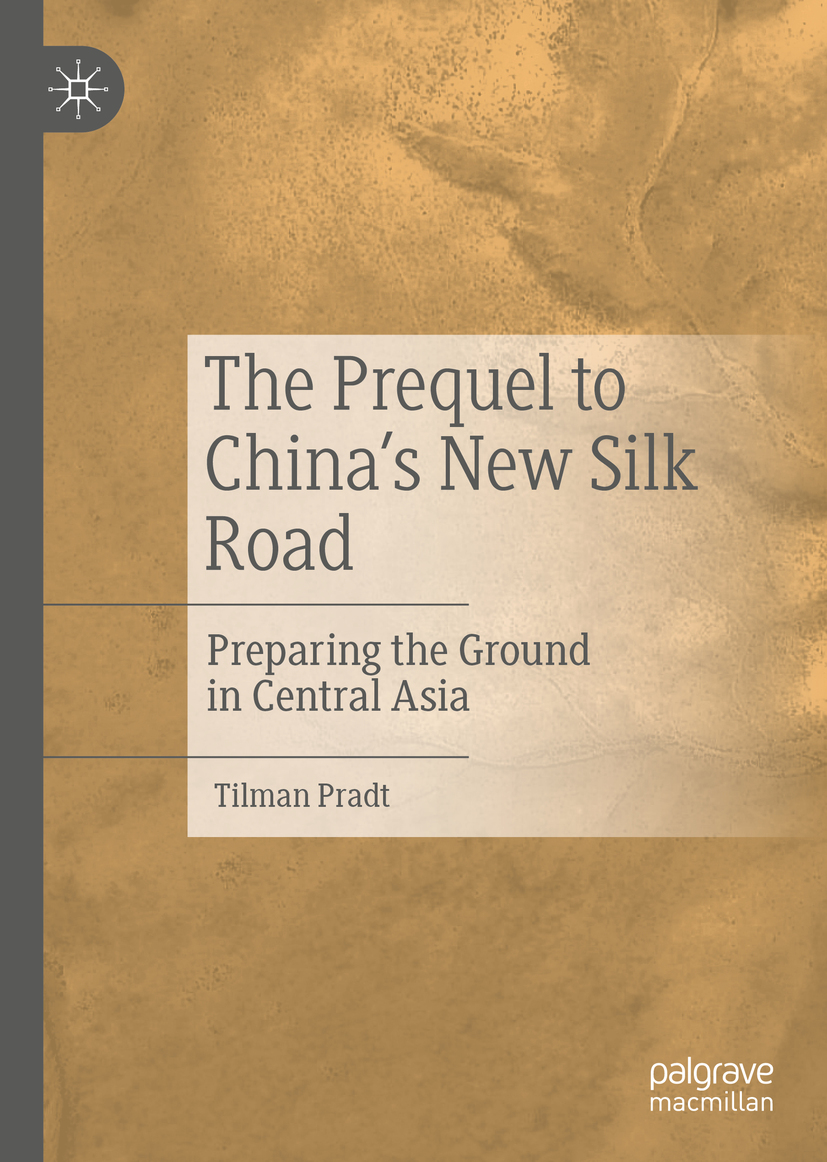
The Prequel to China's New Silk Road This book offers the prequel to China's successful implementation of its New Silk Road, the so-called Belt and Road Initiative (BRI). The preconditions for the establishment of especially the land route between China and Western Europe have been set decades ago in Central Asia. In the political, security, and economic realms, China had to find arrangements with Russia as well as the Central Asian states. Border disputes had to be resolved, a security architecture and political cooperation was lacking. The key to BRI's success today lies in China's successful diplomacy of the 1990s and 2000s. This book tells the exciting story behind the largest geopolitical infrastructure project of our time. POLITICAL SCIENCE,World,Asian
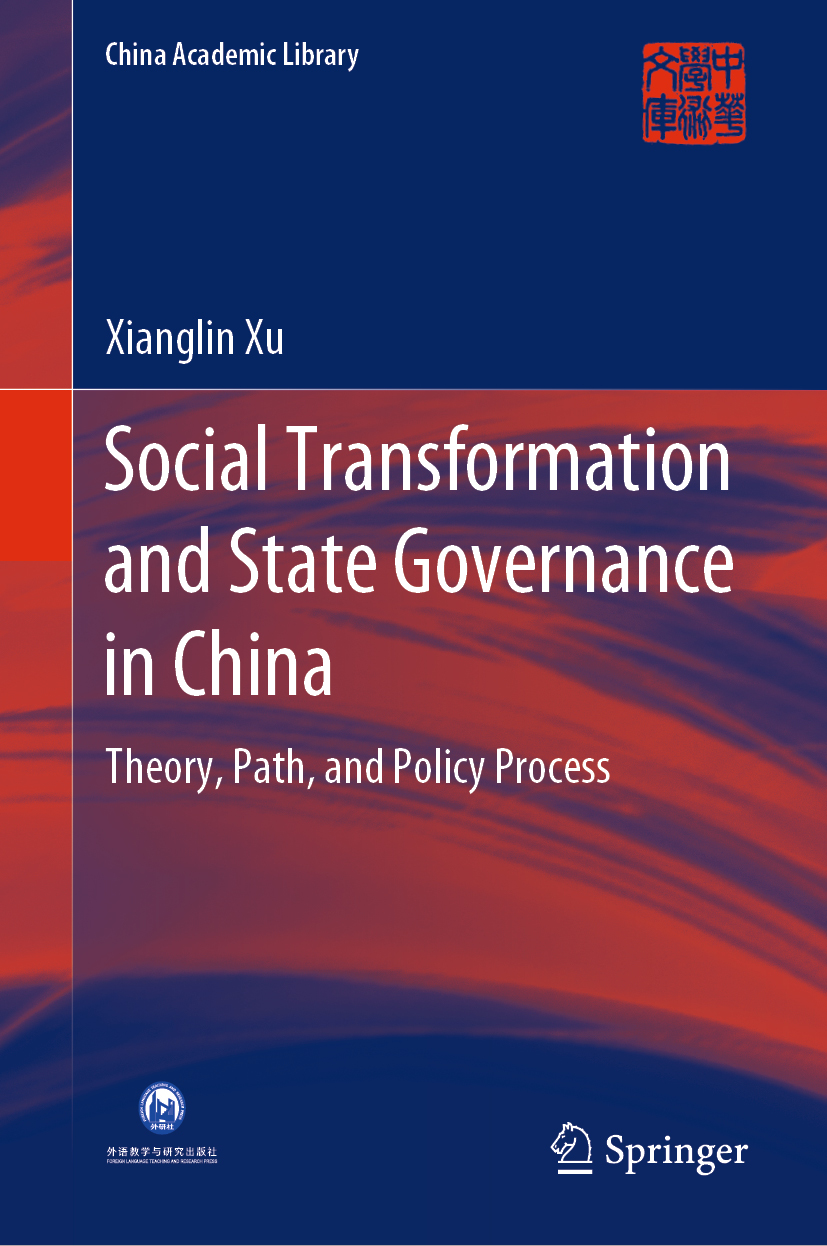
Social Transformation and State Governance in China This volume is a selection of Chinese political scholar Xianglin Xu’s published works spanning nearly 20 years of research that explore and discuss the socio-economic transition in China under state political reform. Contextualized within the decades following the 80s, the author analyzes patterns observed from empirical studies, and breaks down the underlining reasoning, conditions and functionalities behind the incremental reform policies pushed forward by the Party and government. The collection is broken up into four sections: the first provides a general framework and theoretical / historical introduction to social transition research in the case of China; the second section discusses the underpinning logic behind political reform in China and practical concerns; the third section follows with discussions on reform policy practices within China including application and trajectory; the final section concludes with an analysis of reform within state institutional infrastructure and policy innovation. POLITICAL SCIENCE,World,Asian
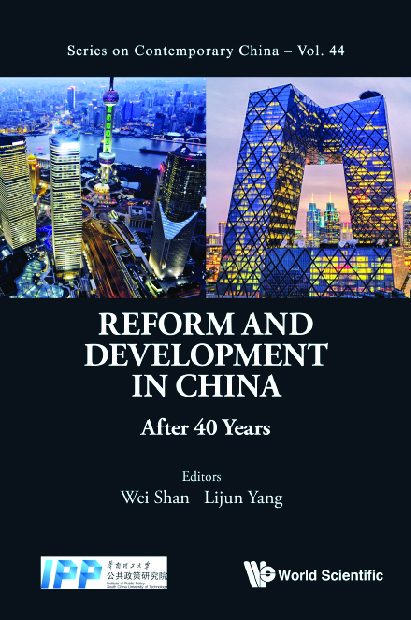
Reform And Development In China This book provides a comprehensive review of China's experience in reform and opening up from political, social, and economic perspectives. It attempts to engage existing scholarly debates in three areas — first, how the party-state has evolved in the past four decades and whether it remains a Leninist system or has departed from this system; second, how public attitudes, values and behavior have been intertwined with institutional change, and how the state is expanding its welfare coverage to enhance regime legitimacy. Second, how China has attempted to explore new engines for its growth, with consideration towards environmental protection and technological progress.Chapters in this book are selected from three years of conference presentations co-organized by the Institute of Public Policy (IPP) at the South China University of Technology and UNESCO. Since 2014, IPP and UNESCO have co-hosted a series of annual international conferences and invited leading scholars from China, Europe, and the US to discuss the major challenges to China and the world. POLITICAL SCIENCE,World,Asian

China's Township System This book is based on an empirical research on the governance and reform of the contemporary township system in China. It provides an insightful and innovative understanding of China's township system. The book consists of four parts. The first part discusses the historical changes, present situation and practical operation of China's township system. The second part compares several practice models of reform, and analyses the motivational forces, path and trend of the reform process. The third part studies the reconstruction of modern township governance system and other relevant institutional innovations. The fourth part focuses on the investigation and case analysis of the actual operation of the township system at multi-dimensional levels. POLITICAL SCIENCE,World,Asian
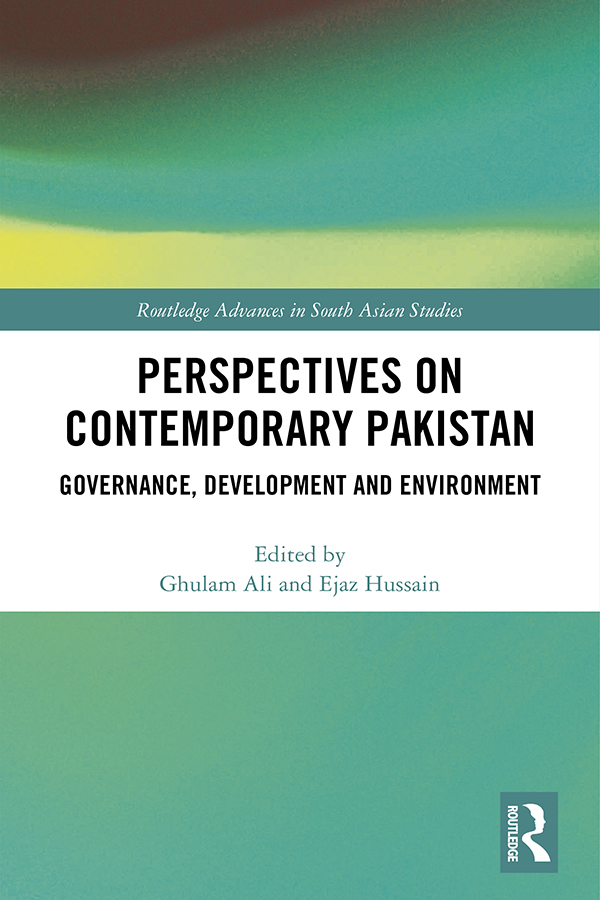
Perspectives on Contemporary Pakistan This book analyses problems of governance, development and environment affecting contemporary Pakistan; issues that lie at the centre of federal and provincial policy deliberations, formulation and implementation. The book offers a comprehensive assessment of the policies, or lack thereof. Authors from a variety of disciplines empirically and conceptually evaluate latest developments, events and data regarding law and order, economic under-performance, social intolerance and climate crisis. The book offers varied perspectives on state sovereignty, civil-military relations, spousal violence, rural development, CPEC, nuclear governance and transboundary climate risk. Arguing that the conclusions should be adopted by the social, political and economic stakeholders of Pakistan, as well as the region at the higher level of governability, the book demonstrates that it would both boost national morale and inspire individuals to further investigate to come up with innovative solutions. Examining some of the most pressing and persistent problems Pakistan and South Asia is facing, the book will be of interest to academics working in the fields of Political Science, in particular South Asian Politics, Development Studies and Environmental Studies. POLITICAL SCIENCE,World,Asian

Xuanzang The saga of the seventh-century Chinese monk Xuanzang, who completed an epic sixteen-year journey to discover the heart of Buddhism at its source in India, is a splendid story of human struggle and triumph. One of China's great heroes, Xuanzang is introduced here for the first time to Western readers in this richly illustrated book. Sally Hovey Wriggins, who journeyed in Xuanzang's footsteps, brings to life a man who transcended common experience. Eight centuries before Columbus, this intrepid pilgrim against the wishes of his emperor travelled on the Silk Road through Central Asia on his way to India. Before his journey ended, he had met most of Asia's important leaders and traversed 10,000 miles in search of Buddhist scriptures. He was both a mountain climber who scaled three of Asia's highest mountain ranges and a desert survivor who nearly died of thirst on the brutal flats; a philosopher and metaphysician; a diplomat who established China's ties to Central Asian and Indian kings; and above all a devout and courageous Buddhist who personally nurtured the growth of Buddhism in China by disseminating the nearly 600 scriptures he carried back from India. Wriggins gives us vivid descriptions of the perils Xuanzang faced, the monasteries he visited (many still standing today), and the eight places of Buddhist pilgrimage in India. Detailed maps and color photographs provide striking evidence of the vast distances involved and the appalling dangers Xuanzang endured; reproductions of Buddhist art from museums around the world capture the glories of this world religion while revealing a cosmopolitan era in which pilgrims were both adventurers and ambassadors of goodwill. An engaging introduction to Buddhism and Buddhist art, this unique book takes the reader on a rousing adventure that also gives a compelling view of Asian history and civilization. POLITICAL SCIENCE,World,Asian
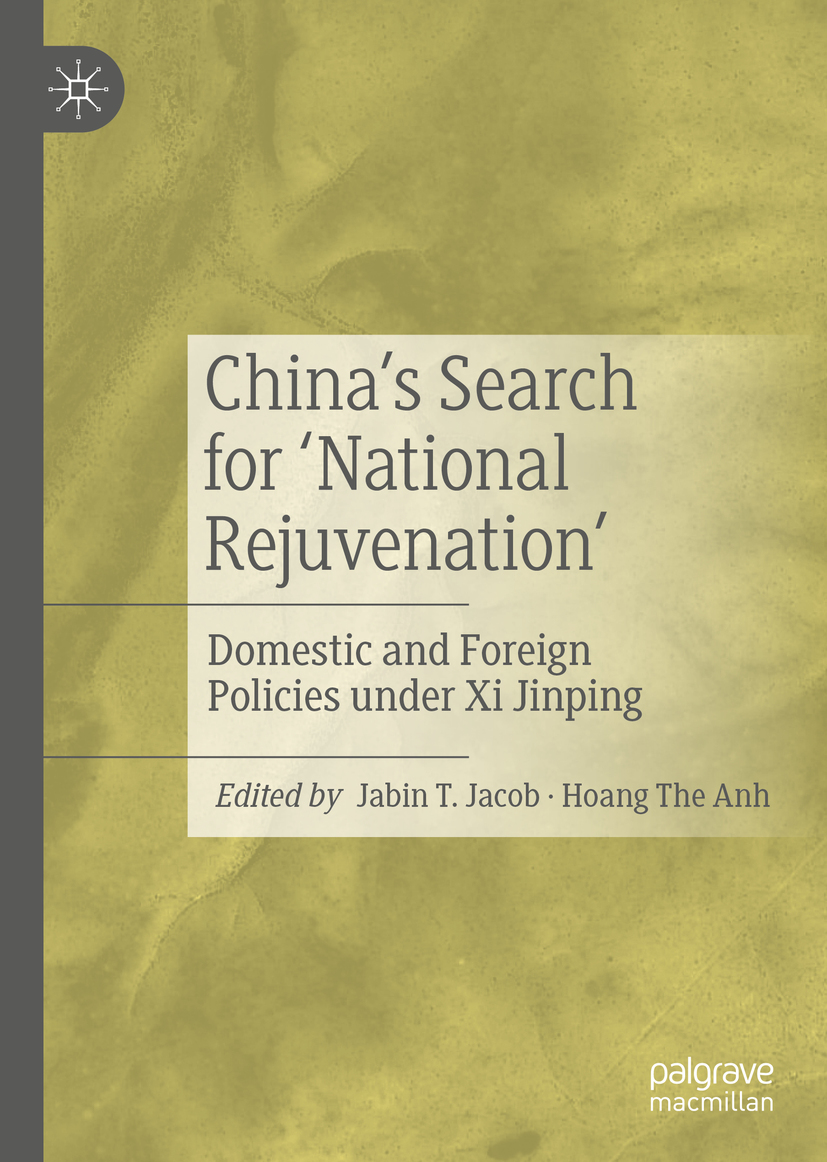
China’s Search for ‘National Rejuvenation’ This volume discusses a range of key domestic forces driving the current Chinese growth ranging from economic reforms to governance practices to analyze their impact and influence at home as well as on China’s foreign and security policies in its near and extended neighbourhood. At the same time, the volume also looks at specific themes like technology, agricultural development, reform of state-owned enterprises and the use of Party bodies to engage in foreign propaganda work among other things to offer examples of the merging of Chinese domestic political and foreign policy interests. In the process, the book offers its readers a better idea of China’s place in the world as the Chinese themselves see it and the implications over time for China, its neighbourhood and the wider world. POLITICAL SCIENCE,World,Asian

China's Quest for Sporting Mega-Events This book vividly elucidates the inseparable nature between politics and sport in China. The holding of sporting mega-events is viewed by the Chinese authorities as a prominent way to push forward the Reform and Opening up, arouse the patriotism among the public, and display national resurgence in the world. Chinese cities thus have keenly quested for the Olympics, the Asian Games and the World University Games since the 1980s. Theoretically, the President, the Premier and the central government should provide all-out support, so boosting the Chinese cities’ odds of success. The reality yet shows that their attitude towards the bids vary from case to case. Through reviewing the 20 bidding cases, this book aims to demystify the reasons behind. The findings provide an in-depth account of (1) how domestic and international political factors determine the state leaders’ blessing and silence as well as the central government’s backing, indifference and opposition, and (2) how the bids for the sporting mega-events are used to serve the broader political goals of the Chinese authorities at home and abroad. Additionally, they shed light on the political strategies to boost the Chinese cities’ chance of success, and the political reasons for their win, loss and discontinuation, in the bidding contests. The book will be a valuable resource for researches interested in the domestic politics and international relations of China. POLITICAL SCIENCE,World,Asian

State Reconstitution in China, Japan and East Africa Presented through an investigation of Sengoku Japan and Republican China, this book proposes an innovative explanation of state formation that focuses on ideational and geographic factors. This study addresses the question; why are some collapsed states able to reconstitute themselves where others have not? Graham F. Odell employs two cases of successful state reconstitution – Republican China (1912-1949) and Sengoku Japan (1477-1615) – to derive a new theoretical framework around this question. These cases are distinct across several significant factors, making them ideal for a research design that seeks to formulate an original theoretical explanation for a phenomenon. Taken together, these two periods of Chinese and Japanese history are paradigmatic cases of state collapse and reconstitution and thus intrinsically compelling to the study of state formation. By developing a new theory of successful state reconstitution through emphasizing the roles of ideology, political symbolism and the geographical distribution of social power, this text provides an answer to the question that has not only scholarly and practical implications, but also a wide geographical applicability. This book will be key reading for scholars interested in matters of international politics, political science, and state formation, especially in East Asia. POLITICAL SCIENCE,World,Asian
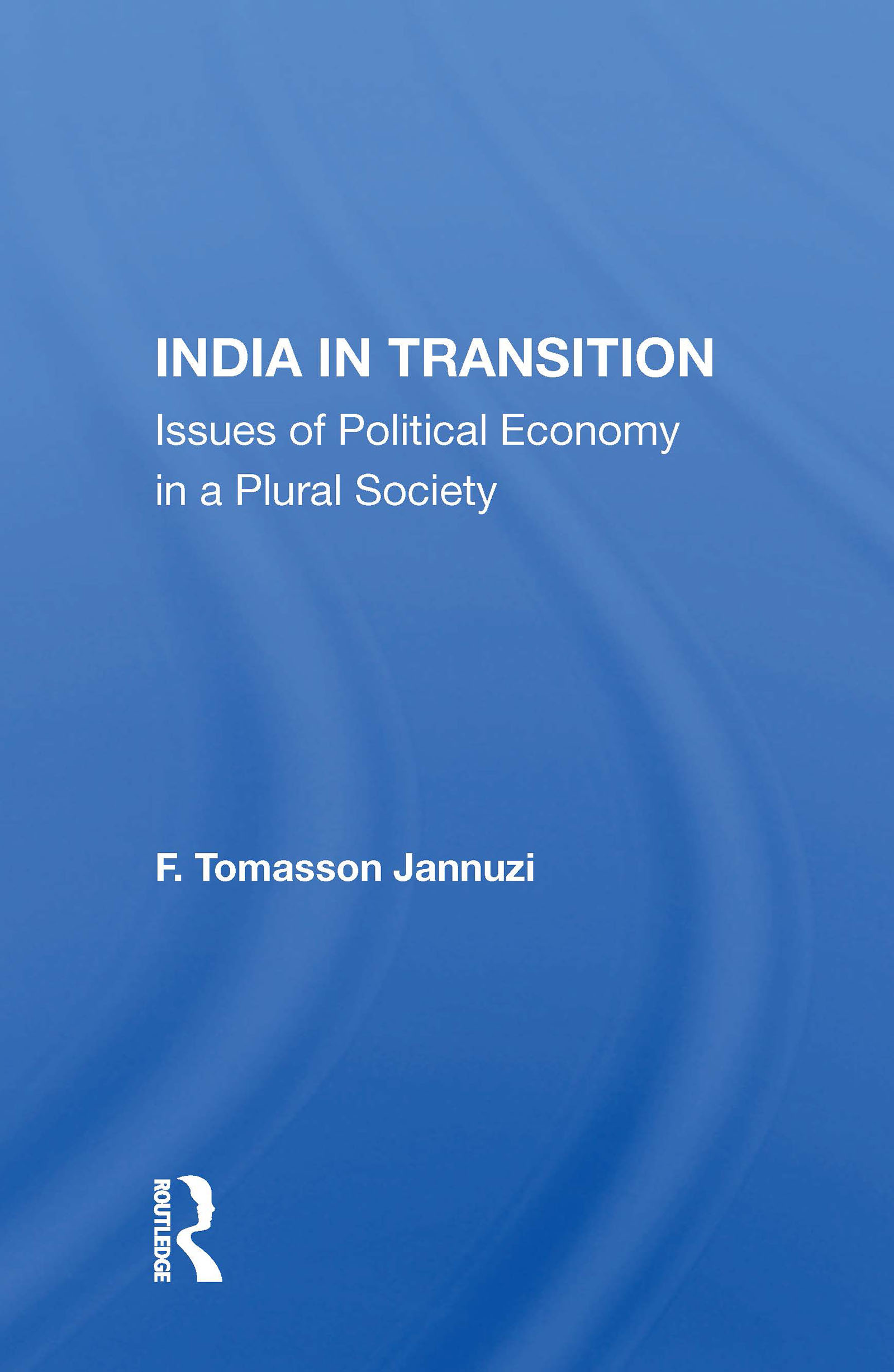
India In Transition In this book, the author makes some generalizations about contemporary India and the years immediately ahead daring to set forth some of his personal concerns for critical review by those in the United States and in India who share in varying degrees his concern for India's future. POLITICAL SCIENCE,World,Asian

New Directions in Japan’s Security While the US-Japan alliance has strengthened since the end of the Cold War, Japan has, almost unnoticed, been building security ties with other partners, in the process reducing the centrality of the US in Japan’s security. This book explains why this is happening. Japan pursued security isolationism during the Cold War, but the US was the exception. Japan hosted US bases and held joint military exercises even while shunning contacts with other militaries. Japan also made an exception to its weapons export ban to allow exports to the US. Yet, since the end of the Cold War, Japan’s security has undergone a quiet transformation, moving away from a singular focus on the US as its sole security partner. Tokyo has begun diversifying its security ties. This book traces and explains this diversification. The country has initiated security dialogues with Asian neighbors, assumed a leadership role in promoting regional multilateral security cooperation, and begun building bilateral security ties with a range of partners, from Australia and India to the European Union. Japan has even lifted its ban on weapons exports and co-development with non-US partners. This edited volume explores this trend of decreasing US centrality alongside the continued, and perhaps even growing, security (inter) dependence with the US. New Directions in Japan’s Security is an essential resource for scholars focused on Japan’s national security. It will also interest on a wider basis those wishing to understand why Japan is developing non-American directions in its security strategy. POLITICAL SCIENCE,World,Asian
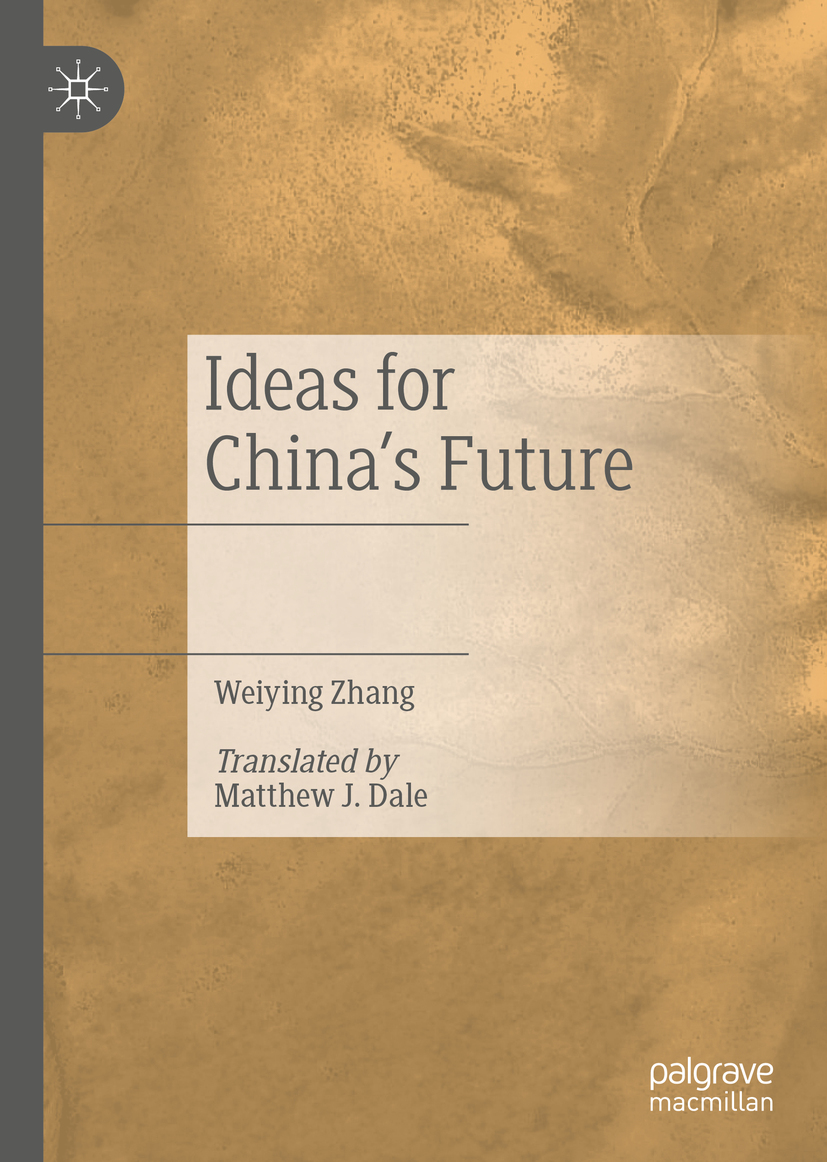
Ideas for China’s Future This book attempts to convey that ideas matter and China needs right ideas to defeat wrong ideas and to guide its future reform. The successes that China has accomplished over the last 40 years of reform and opening were the result of ideas defeating interests. After the end of the “Cultural Revolution,†Deng Xiaoping initiated market-oriented Reform and Opening because he had new ideas. While China has made great progress in both economic and social development since the beginning of reform and opening, there is still a long way to go to become a liberal society. Although the ideas of political leaders are crucial in the short term for social transformation to take place, the ideas of the common people play a more important role in the long term. The types of new ideas that China needs are proposed in this book. POLITICAL SCIENCE,World,Asian

Indigenous Australia for Dummies A comprehensive, relevant, and accessible look at all aspects of Indigenous Australian history and culture What is The Dreaming? How many different Indigenous tribes and languages once existed in Australia? What is the purpose of a corroboree? What effect do the events of the past have on Indigenous peoples today? Indigenous Australia For Dummies answers these questions and countless others about the oldest race on Earth. It explores Indigenous life in Australia before 1770, the impact of white settlement, the ongoing struggle by Aboriginal and Torres Strait Islander peoples to secure their human rights and equal treatment under the law, and much more. Celebrating the contributions of Indigenous people to contemporary Australian culture, the book explores Indigenous art, music, dance, literature, film, sport, and spirituality. It discusses the concept of modern Indigenous identity and examines the ongoing challenges facing Indigenous communities today, from health and housing to employment and education, land rights, and self-determination. Explores significant political moments—such as Paul Keating's Redfern Speech and Kevin Rudd's apology, and more Profiles celebrated people and organisations in a variety of fields, from Cathy Freeman to Albert Namatjira to the Bangarra Dance Theatre and the National Aboriginal Radio Service Challenges common stereotypes about Indigenous people and discusses current debates, such as a land rights and inequalities in health and education This book will enlighten readers of all backgrounds about the history, struggles and triumphs of the diverse, proud, and fascinating peoples that make up Australia's Indigenous communities. With a foreword by former PM Malcolm Fraser, Indigenous Australia For Dummies is a must-read account of Australia's first people. 'Indigenous Australia For Dummies is an important contribution to the broad debate and to a better understanding of our past history. Hopefully it will influence future events.'—Former Prime Minister Malcolm Fraser POLITICAL SCIENCE,World,Australian & Oceanian
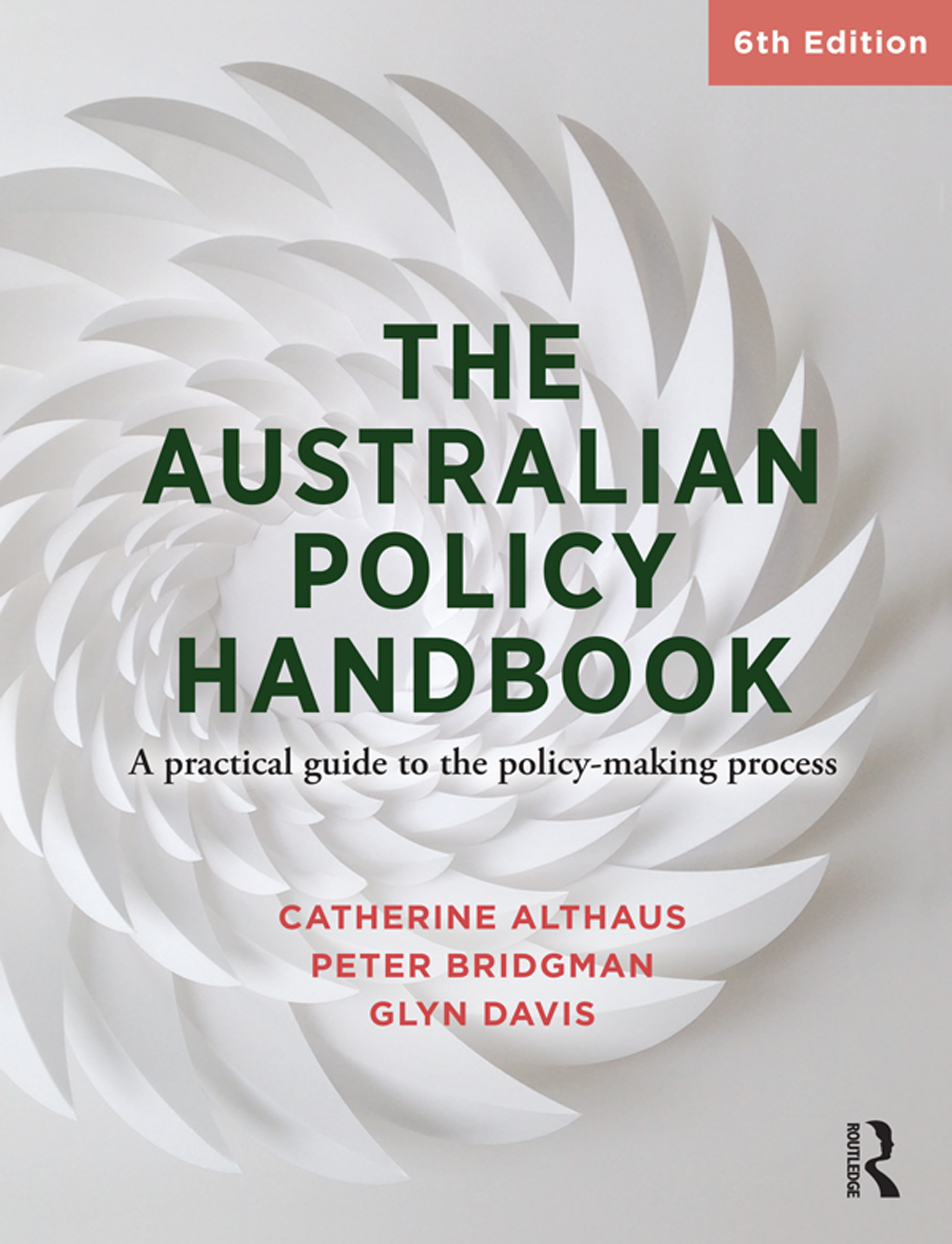
The Australian Policy Handbook Public policy permeates every aspect of our lives. It is the stuff of government, justifying taxes, driving legislation, and shaping our social services. Public policy gives us roads, railways and airports, emergency services, industry development, and natural resource management. While politicians make the decisions, public servants provide analysis and support for those choices. Drawing on their extensive practical experience, the authors outline the processes used in making public policy. They systematically explain the relationships between political decision-makers, public service advisers, other community participants, and those charged with implementing the programs that result. The sixth edition of this widely used introduction is fully updated, and includes new material on the professionalisation of politicians, the role of opposition members, loss of corporate memory in the public service, addressing systemic policy failure, nudge economics and the impact of social media and the sharing economy on policy making and government. 'An invaluable guide for practitioners, academics and students to the craft of policy analysis, development and evaluation. It is an important resource for those with a commitment to sound evidence-based public policy.' Ken Smith, ANZSOG CEO and Dean 'An enduring and important contribution to the field. Althaus, Bridgman and Davis' pioneering policy cycle approach continues to offer vital insights into the policy-making process in Australia and internationally.' Lisa Paul AO PSM, Former Secretary of the Department of Education POLITICAL SCIENCE,World,Australian & Oceanian
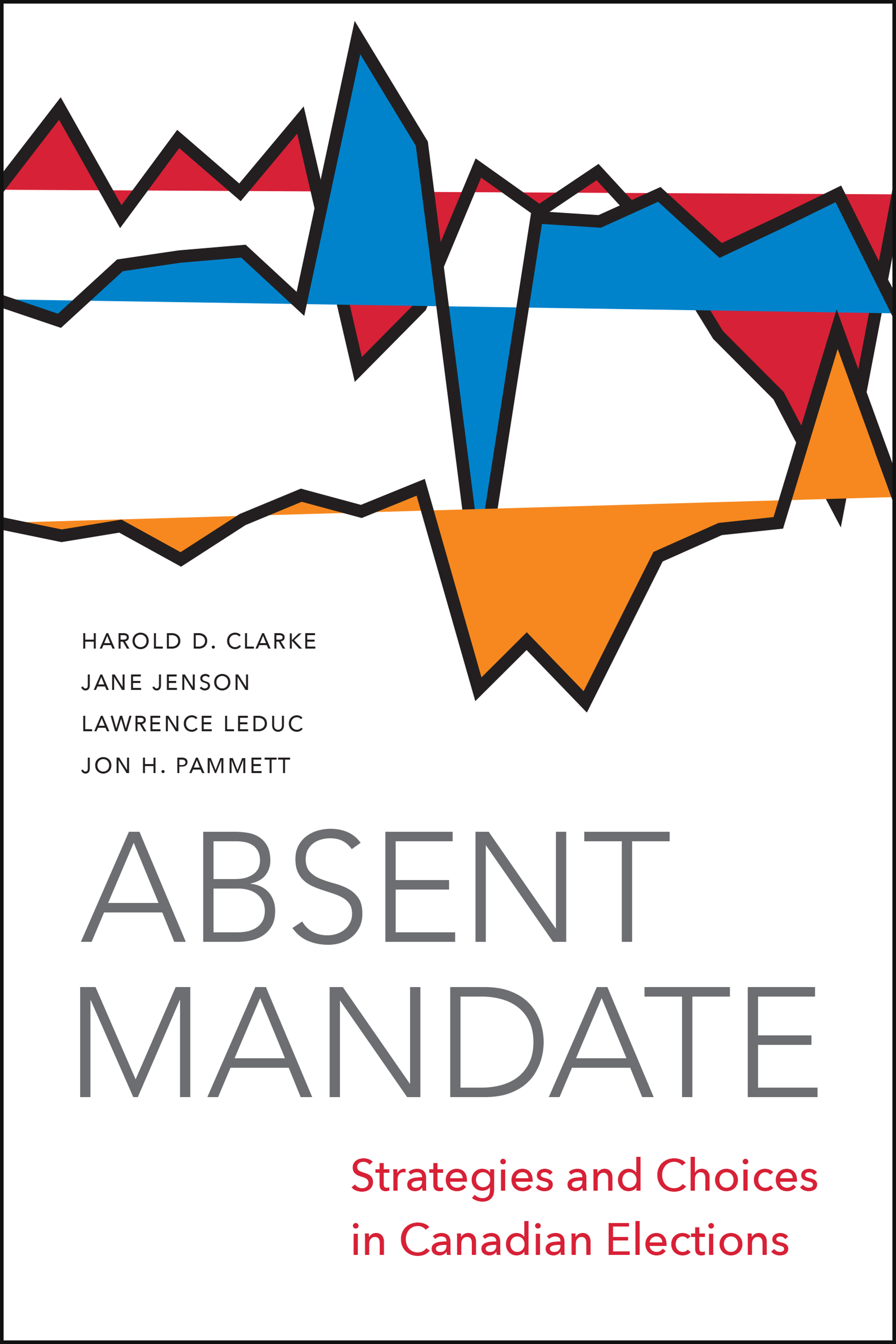
Absent Mandate Dominated by discussions of broad national problems, media tactics gone amiss, and the personal lives of party leaders, Canadian election campaigns have led to substantial public discontent. POLITICAL SCIENCE,World,Canadian
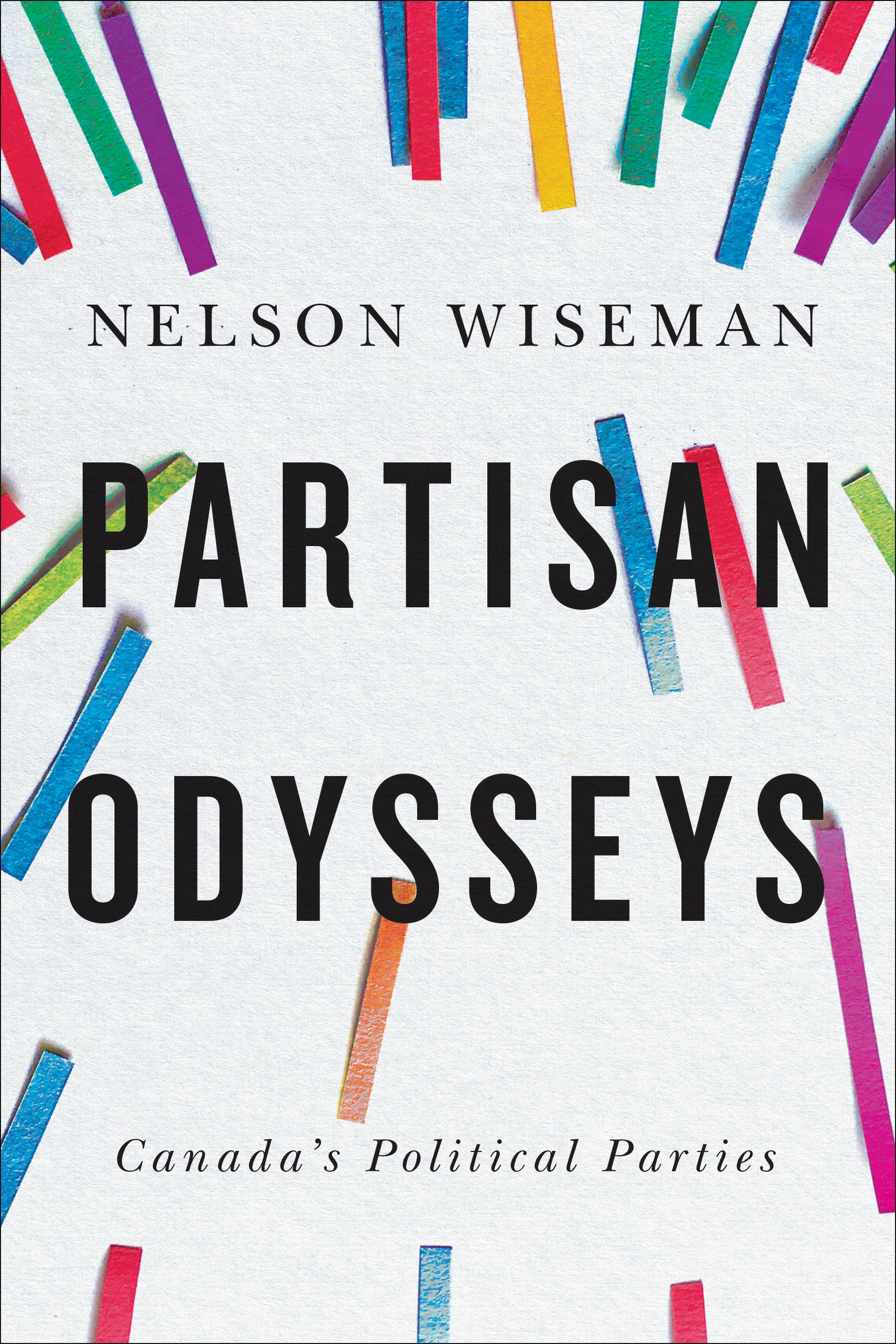
Partisan Odysseys Motifs or recurring elements in Canadian party politics speak to dominant ideas of the era. Partisan Odysseys looks at how political parties have adjusted, adapted, and sometimes reinvented themselves in response to these cultural cues. POLITICAL SCIENCE,World,Canadian
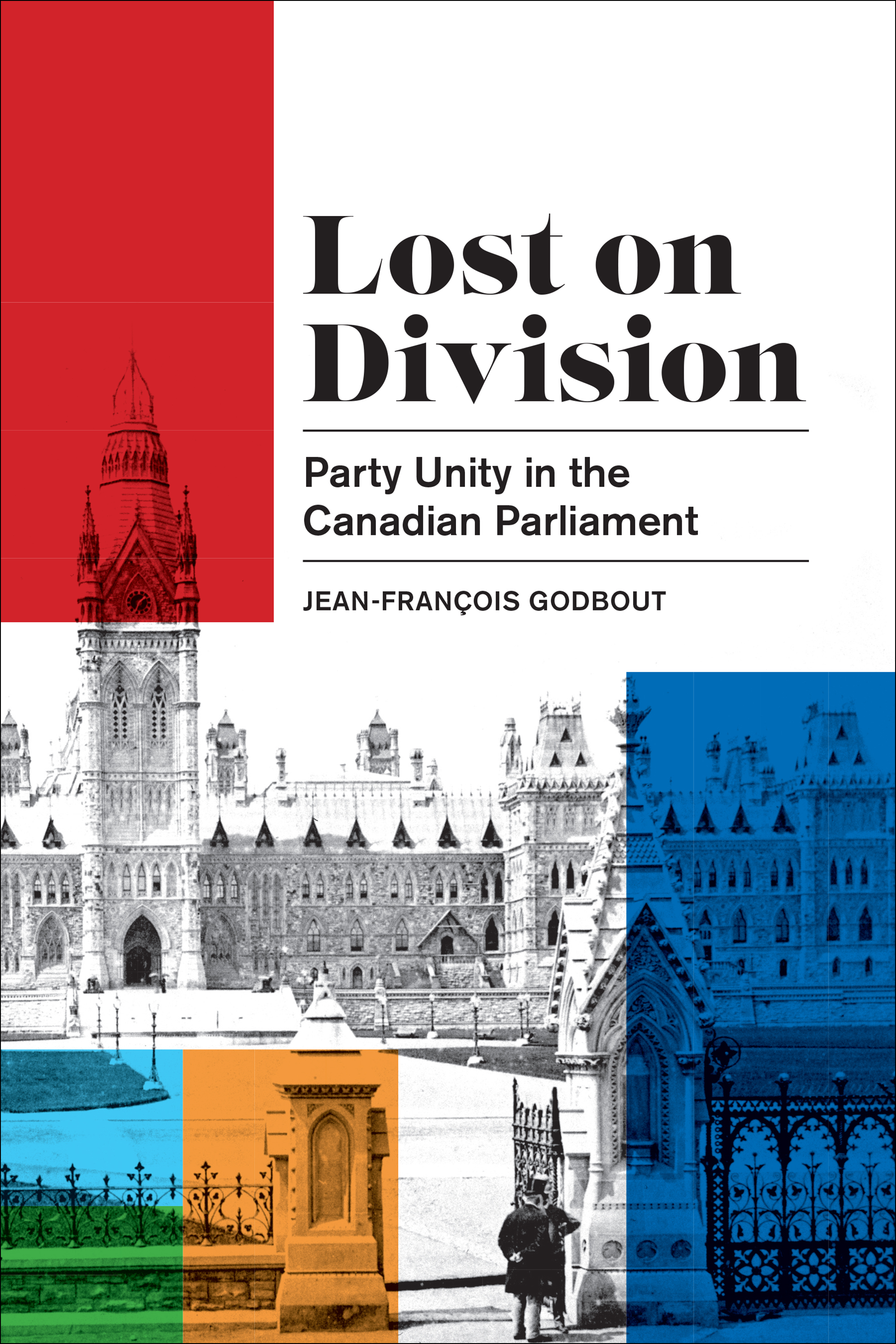
Lost on Division Bridging Canadian party politics and legislative studies, Lost on Division is the most authoritative study available on the development of parliamentary institutions in Canada. POLITICAL SCIENCE,World,Canadian

Narcoland The product of five years’ investigative reporting, the subject of intense national controversy, and the source of death threats that forced the National Human Rights Commission to assign two full-time bodyguards to its author, Anabel Hernández, Narcoland has been a publishing and political sensation in Mexico. The definitive history of the drug cartels, Narcoland takes readers to the front lines of the “war on drugs,” which has so far cost more than 60,000 lives in just six years. Hernández explains in riveting detail how Mexico became a base for the mega-cartels of Latin America and one of the most violent places on the planet. At every turn, Hernández names names – not just the narcos, but also the politicians, functionaries, judges and entrepreneurs who have collaborated with them. In doing so, she reveals the mind-boggling depth of corruption in Mexico’s government and business elite. Hernández became a journalist after her father was kidnapped and killed and the police refused to investigate without a bribe. She gained national prominence in 2001 with her exposure of excess and misconduct at the presidential palace, and previous books have focused on criminality at the summit of power, under presidents Vicente Fox and Felipe Calderón. In awarding Hernández the 2012 Golden Pen of Freedom, the World Association of Newspapers and News Publishers noted, “Mexico has become one of the most dangerous countries in the world for journalists, with violence and impunity remaining major challenges in terms of press freedom. In making this award, we recognize the strong stance Ms. Hernández has taken, at great personal risk, against drug cartels.” POLITICAL SCIENCE,World,Caribbean & Latin American
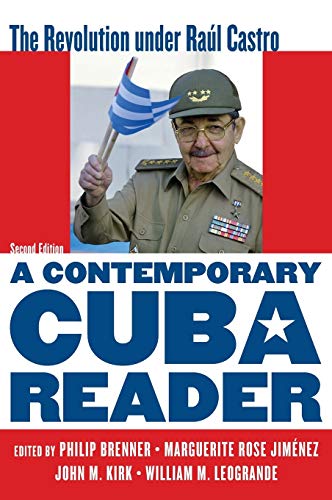
A Contemporary Cuba Reader This completely revised and updated edition focuses on Cuba since Raúl Castro took over the country’s leadership in 2006. A Contemporary Cuba Reader brings together the best recent scholarship and writing on Cuban politics, economics, foreign relations, society, and culture in present-day Cuba. Ideally suited for students and general readers seeking to understand this still-contentious and controversial island, the book includes a substantive introduction setting the historical context, as well as part introductions and a chronology. Supplementary resources for students and professors are available on the R&L website. POLITICAL SCIENCE,World,Caribbean & Latin American
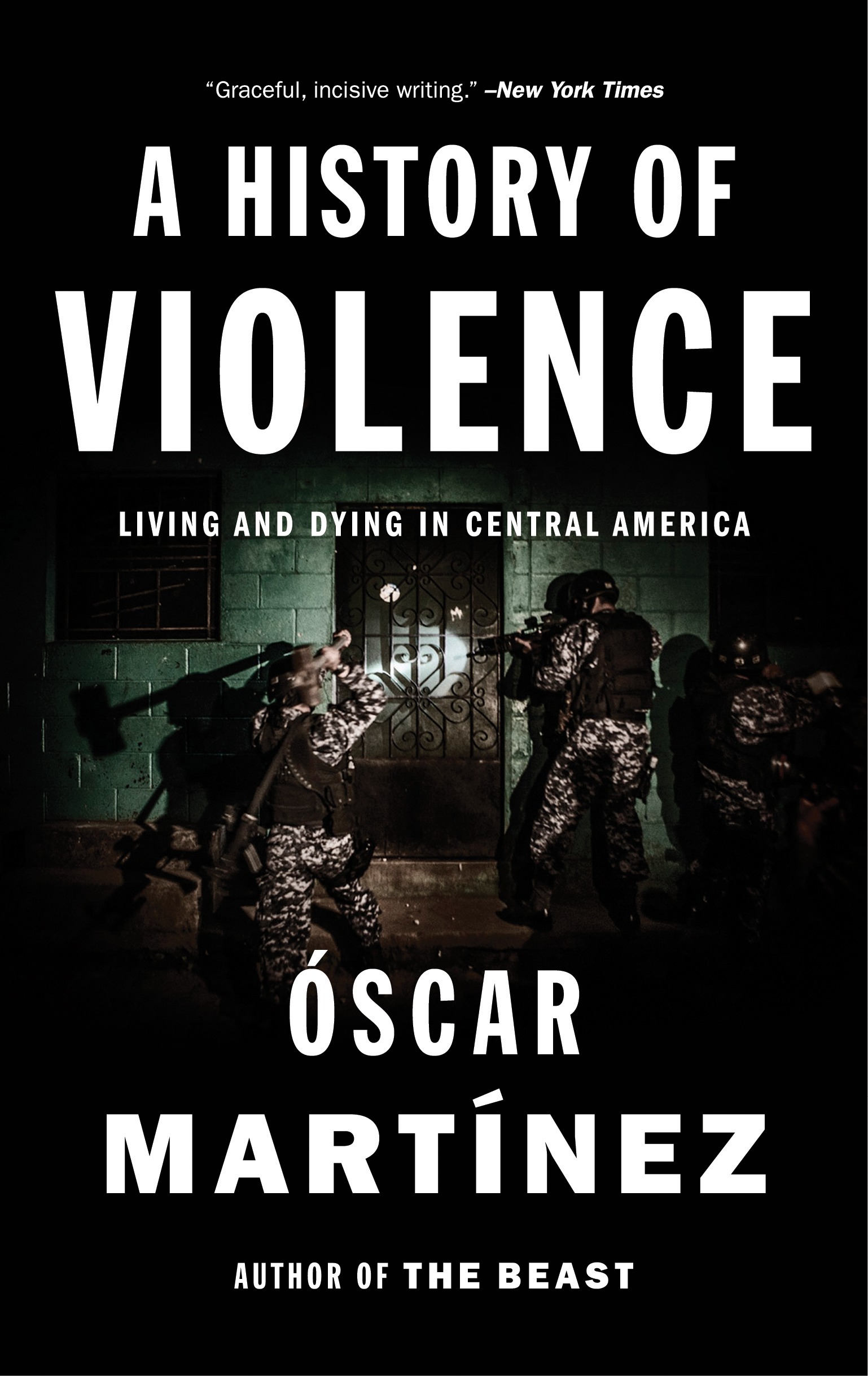
A History of Violence This is a book about one of the deadliest places in the world El Salvador and Honduras have had the highest homicide rates in the world over the past ten years, with Guatemala close behind. Every day more than 1,000 people—men, women, and children—flee these three countries for North America. Óscar Martínez, author of The Beast, named one of the best books of the year by the Economist, Mother Jones, and the Financial Times, fleshes out these stark figures with true stories, producing a jarringly beautiful and immersive account of life in deadly locations. Martínez travels to Nicaraguan fishing towns, southern Mexican brothels where Central American women are trafficked, isolated Guatemalan jungle villages, and crime-ridden Salvadoran slums. With his precise and empathetic reporting, he explores the underbelly of these troubled places. He goes undercover to drink with narcos, accompanies police patrols, rides in trafficking boats and hides out with a gang informer. The result is an unforgettable portrait of a region of fear and a subtle analysis of the North American roots and reach of the crisis, helping to explain why this history of violence should matter to all of us. POLITICAL SCIENCE,World,Caribbean & Latin American

The Hollywood Kid The compelling story of the life and death of a Salvadoran gangster As a boy, Miguel Ángel Tobar’s small town in El Salvador was torn apart by guerrillas and US- backed death squads. Still a preteen, he joined a different kind of death squad—the Hollywood Locos Salvatrucha—a clique of the Mara Salvatruchas, better known as MS-13. This international criminal organization began on the streets of Los Angeles in the 1980s, as Salvadoran children, whose families had fled their country’s civil war, banded together to defend themselves from LA gangs. Denied refugee status, the Salvadorans found themselves pushed into the shadows and besieged by violence, and MS-13 itself mutated into a gang. When large-scale US deportations began, violence was exported from the United States to El Salvador, helping make it one of the world’s deadliest countries and in turn propelling new waves of refugees northward. The Salvadoran journalist Óscar Martinez and his anthropologist brother Juan José Martínez got to know the Hollywood Kid when he informed on MS-13. In his hideaway shack, he recounted a life of killing—a death toll of more than fifty rival gang members—until his own murder ended the story. Vivid and violent, The Hollywood Kid brings a brutal world to life, illustrating the geopolitical forces propelling a country toward ever more vicious extremes. POLITICAL SCIENCE,World,Caribbean & Latin American

Who Killed Berta Caceres? A deeply affecting–and infuriating–portrait of the life and death of a courageous indigenous leader The first time Honduran indigenous leader Berta Cáceres met the journalist Nina Lakhani, Cáceres said, ‘The army has an assassination list with my name at the top. I want to live, but in this country there is total impunity. When they want to kill me, they will do it.’ In 2015, Cáceres won the Goldman Prize, the world’s most prestigious environmental award, for leading a campaign to stop construction of an internationally funded hydroelectric dam on a river sacred to her Lenca people. Less than a year later she was dead. Lakhani tracked Cáceres remarkable career, in which the defender doggedly pursued her work in the face of years of threats and while friends and colleagues in Honduras were exiled and killed defending basic rights. Lakhani herself endured intimidation and harassment as she investigated the murder. She was the only foreign journalist to attend the 2018 trial of Cáceres’s killers, where state security officials, employees of the dam company and hired hitmen were found guilty of murder. Many questions about who ordered and paid for the killing remain unanswered. Drawing on more than a hundred interviews, confidential legal filings, and corporate documents unearthed after years of reporting in Honduras, Lakhani paints an intimate portrait of an extraordinary woman in a state beholden to corporate powers, organised crime, and the United States. POLITICAL SCIENCE,World,Caribbean & Latin American
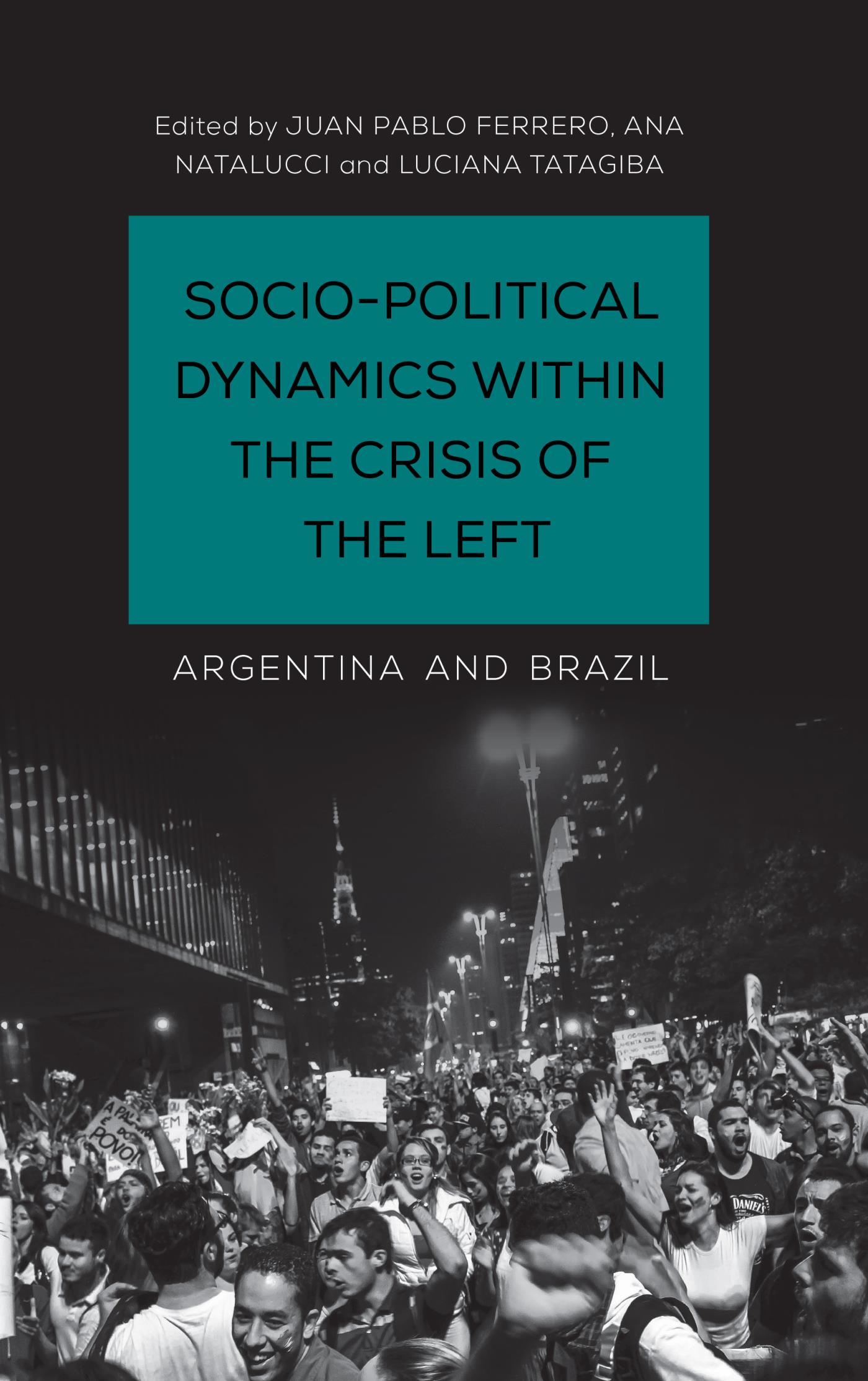
Socio-Political Dynamics within the Crisis of the Left This collection studies the gestation of the crisis of the left-turn consensus dominant in Argentina and Brazil for the past 15 years and the emerging socio-political dynamics developing in this particular context of change. POLITICAL SCIENCE,World,Caribbean & Latin American
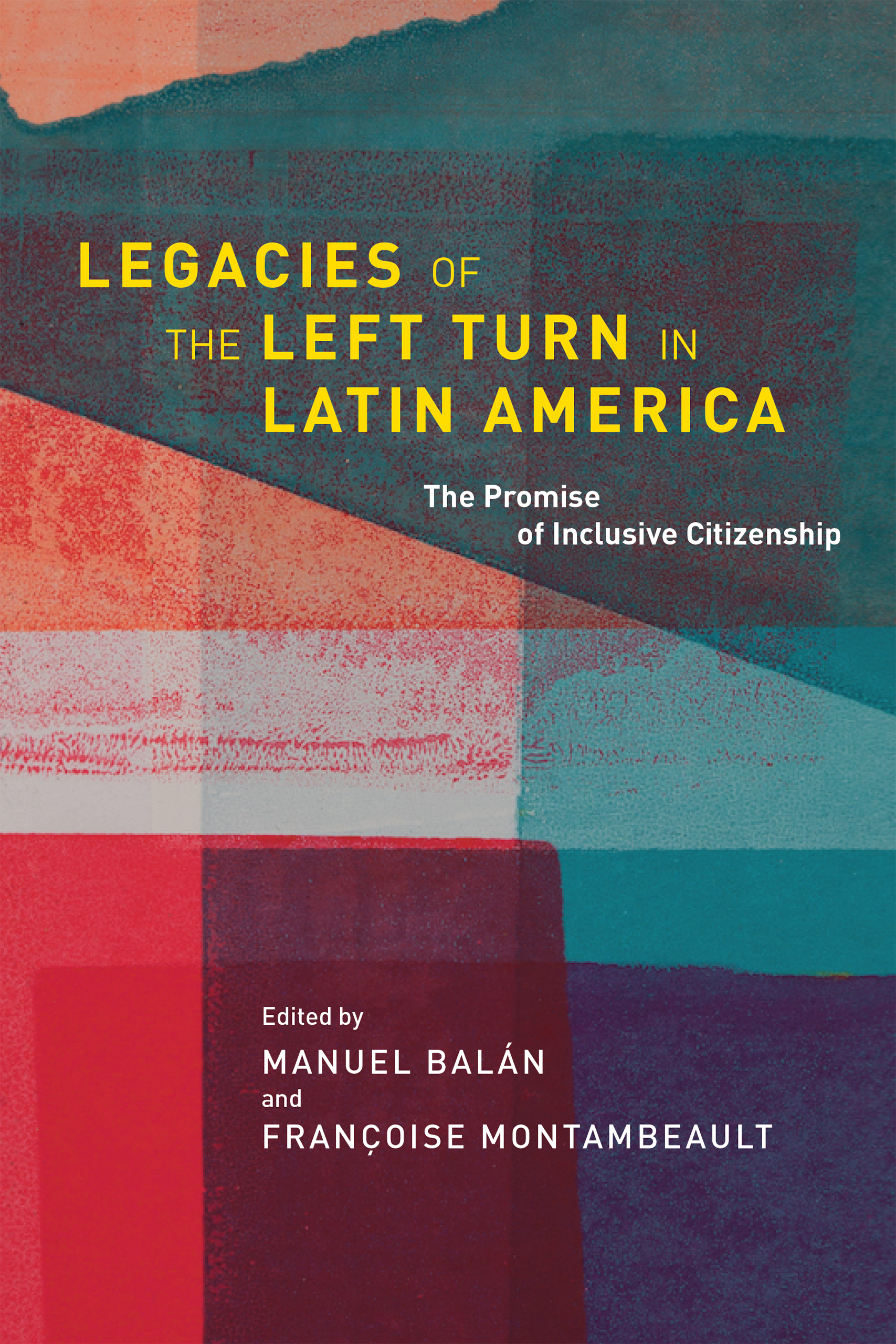
Legacies of the Left Turn in Latin America Legacies of the Left Turn in Latin America: The Promise of Inclusive Citizenship contains original essays by a diverse group of leading and emerging scholars from North America, Europe, and Latin America. The book speaks to wide-ranging debates on democracy, the left, and citizenship in Latin America. What were the effects of a decade and a half of left and center-left governments? The central purpose of this book is to evaluate both the positive and negative effects of the Left turn on state-society relations and inclusion. Promises of social inclusion and the expansion of citizenship rights were paramount to the center-left discourses upon the factions' arrival to power in the late 1990s and early 2000s. This book is a first step in understanding to what extent these initial promises were or were not fulfilled, and why. In analyzing these issues, the authors demonstrate that these years yield both signs of progress in some areas and the deepening of historical problems in others. The contributors to this book reveal variation among and within countries, and across policy and issue areas such as democratic institution reforms, human rights, minorities’ rights, environmental questions, and violence. This focus on issues rather than countries distinguishes the book from other recent volumes on the left in Latin America, and the book will speak to a broad and multi-dimensional audience, both inside and outside the academic world. Contributors: Manuel Balán, Françoise Montambeault, Philip Oxhorn, Maxwell A. Cameron, Kenneth M. Roberts, Nathalia Sandoval-Rojas, Daniel M. Brinks, Benjamin Goldfrank, Roberta Rice, Elizabeth Jelin, Celina Van Dembroucke, Nora Nagels, Merike Blofield, Jordi DÃez, Eve Bratman, Gabriel Kessler, Olivier Dabène, Jared Abbott, Steve Levitsky POLITICAL SCIENCE,World,Caribbean & Latin American
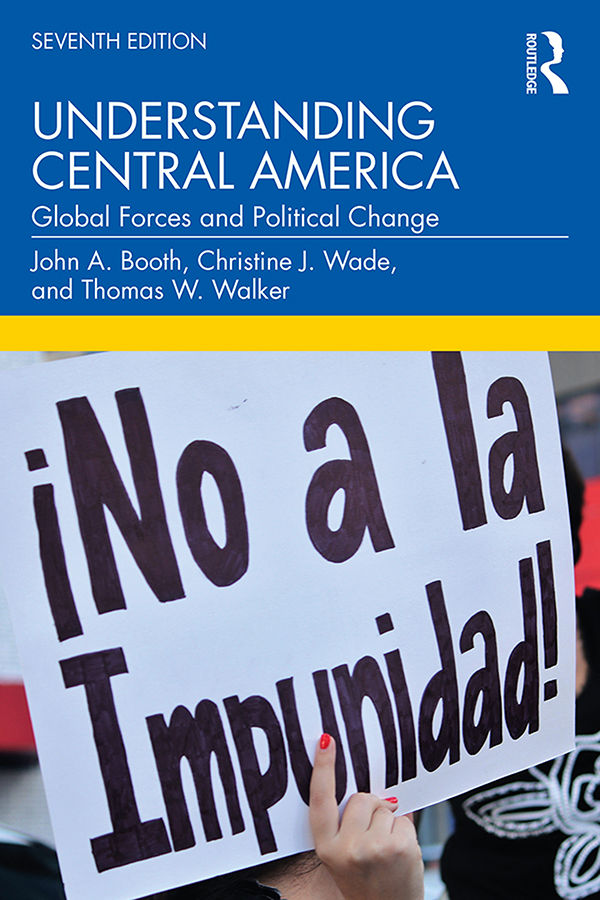
Understanding Central America In this seventh edition, John A. Booth, Christine J. Wade, and Thomas W. Walker update a classic in the field which invites students to explore the histories, economies, and politics of Costa Rica, Nicaragua, El Salvador, Guatemala, and Honduras. Covering the region's political and economic development from the early 1800s onward, the authors bring the Central American story up to date. New to the 7th Edition: Analysis of trends in human rights performance, political violence, and evolution of regime types; Updated findings from surveys to examine levels of political participation and support for democratic norms among Central Americans; Historical and current-era material on indigenous peoples and other racial minorities; Discussion of popular attitudes toward political rights for homosexuals, and LGBTQ access to public services; Discussion of women’s rights and access to reproductive health services, and women’s integration into elective offices; Tracing evolving party systems, national elections, and US policy toward the region under the Obama and Trump administrations; Central America’s international concerns including Venezuela’s shrinking role as an alternative source of foreign aid and antagonist to US policy in the region, and migration among and through Central American nations. Understanding Central America is an ideal text for all students of Latin American politics and is highly recommended for courses on Central American politics, social systems, and history. POLITICAL SCIENCE,World,Caribbean & Latin American
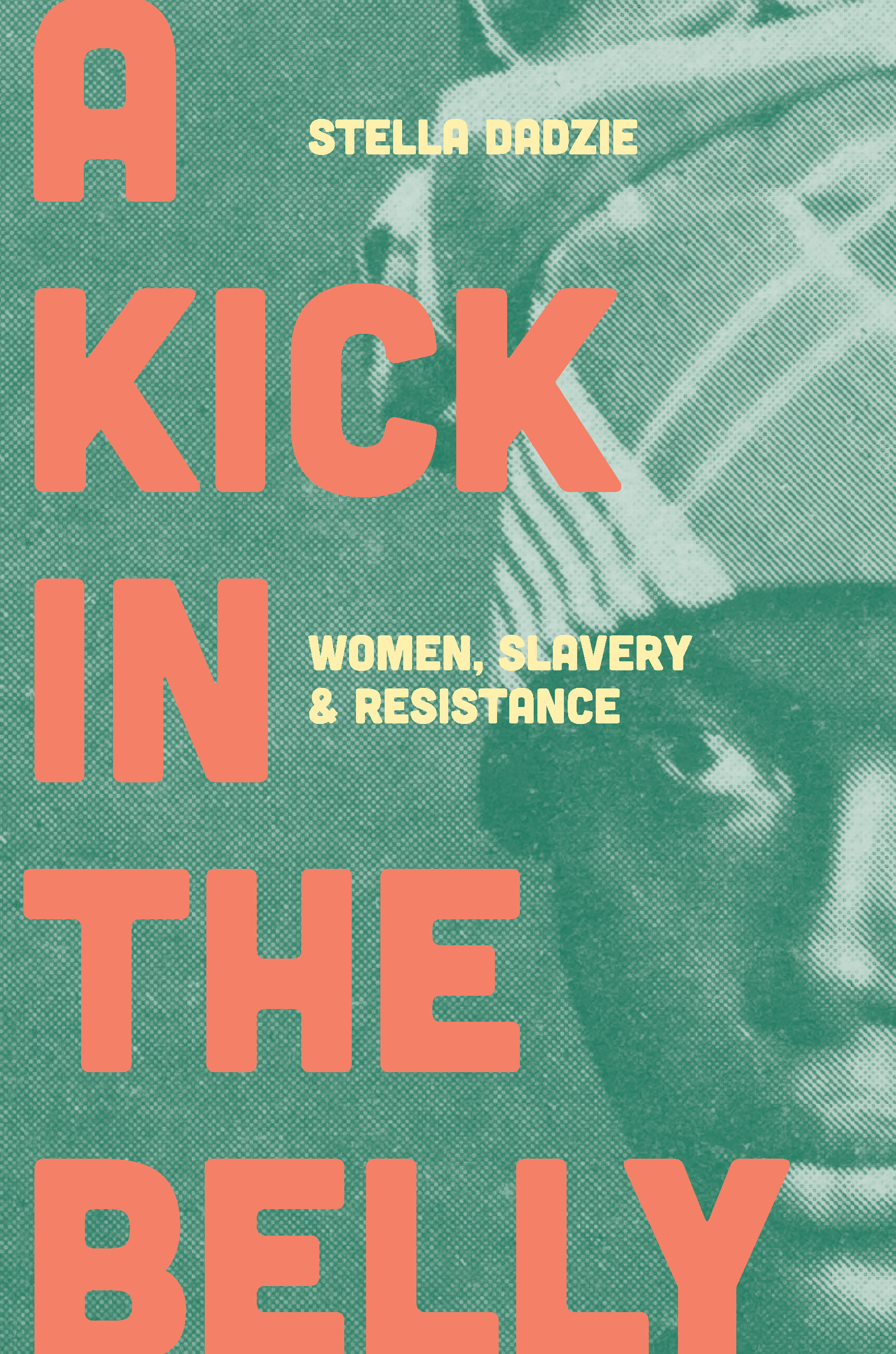
A Kick in the Belly The story of the enslaved West Indian women in the struggle for freedom Enslaved West Indian women had few opportunities to record their stories for posterity. Yet from their dusty footprints and the umpteen small clues they left for us to unravel, there’s no question that they earned their place in history. Pick any Caribbean island and you’ll find race, skin colour and rank interacting with gender in a unique and often volatile way. In A Kick in the Belly, Stella Dadzie follows the evidence, and finds women played a distinctly female role in the development of a culture of slave resistance—a role that was not just central, but downright dynamic. From the coffle-line to the Great House, enslaved women found ways of fighting back that beggar belief. Whether responding to the horrendous conditions of plantation life, the sadistic vagaries of their captors or the “peculiar burdens of their sex,” their collective sanity relied on a highly subversive adaptation of the values and cultures they smuggled with them naked from different parts of Africa. By sustaining or adapting remembered cultural practices, they ensured that the lives of chattel slaves retained both meaning and purpose. A Kick in the Belly makes clear that their subtle acts of insubordination and their conscious acts of rebellion came to undermine the very fabric and survival of West Indian slavery. POLITICAL SCIENCE,World,Caribbean & Latin American

Contemporary Mexican Politics This comprehensive and engaging text explores contemporary Mexico's political, economic, and social development and examines the most important policy issues facing the country today. Readers will find this widely praised book continues to be the most current and accessible work available on Mexico’s politics and policy. POLITICAL SCIENCE,World,Caribbean & Latin American

Fighting for Abortion Rights in Latin America Although they share similar socio-economic and cultural characteristics as well as their recent political histories, Argentina, Chile and Uruguay differ radically in their abortion policies. In this book, Cora Fernández Anderson examines the role social movements play in abortion reform to show how different interaction patterns with state actors have led to three different policy outcomes: comprehensive abortion reform in Uruguay; moderate abortion reform in Chile; and no legal abortion reform in Argentina. Synthesizing a broad range of literature and drawing on in-depth field and archival research, she analyzes the strength of the campaigns for abortion reform, their relationships with leftist parties in power and the context of Church–state relations to explain this diverging trajectory in policy reform. A masterly analysis of how social movements, the power of institutions and Executive preferences have strong explanatory power, Fighting for Abortion Rights in Latin America is a perfect supplement for classes on gender and global politics. POLITICAL SCIENCE,World,Caribbean & Latin American

Fifty Years of Peasant Wars in Latin America Informed by Eric Wolf’s Peasant Wars of the Twentieth Century, published in 1969, this book examines selected peasant struggles in seven Latin American countries during the last fifty years and suggests the continuing relevance of Wolf’s approach. The seven case studies are preceded by an Introduction in which the editors assess the continuing relevance of Wolf’s political economy. The book concludes with Gavin Smith’s reflection on reading Eric Wolf as a public intellectual today. POLITICAL SCIENCE,World,Caribbean & Latin American
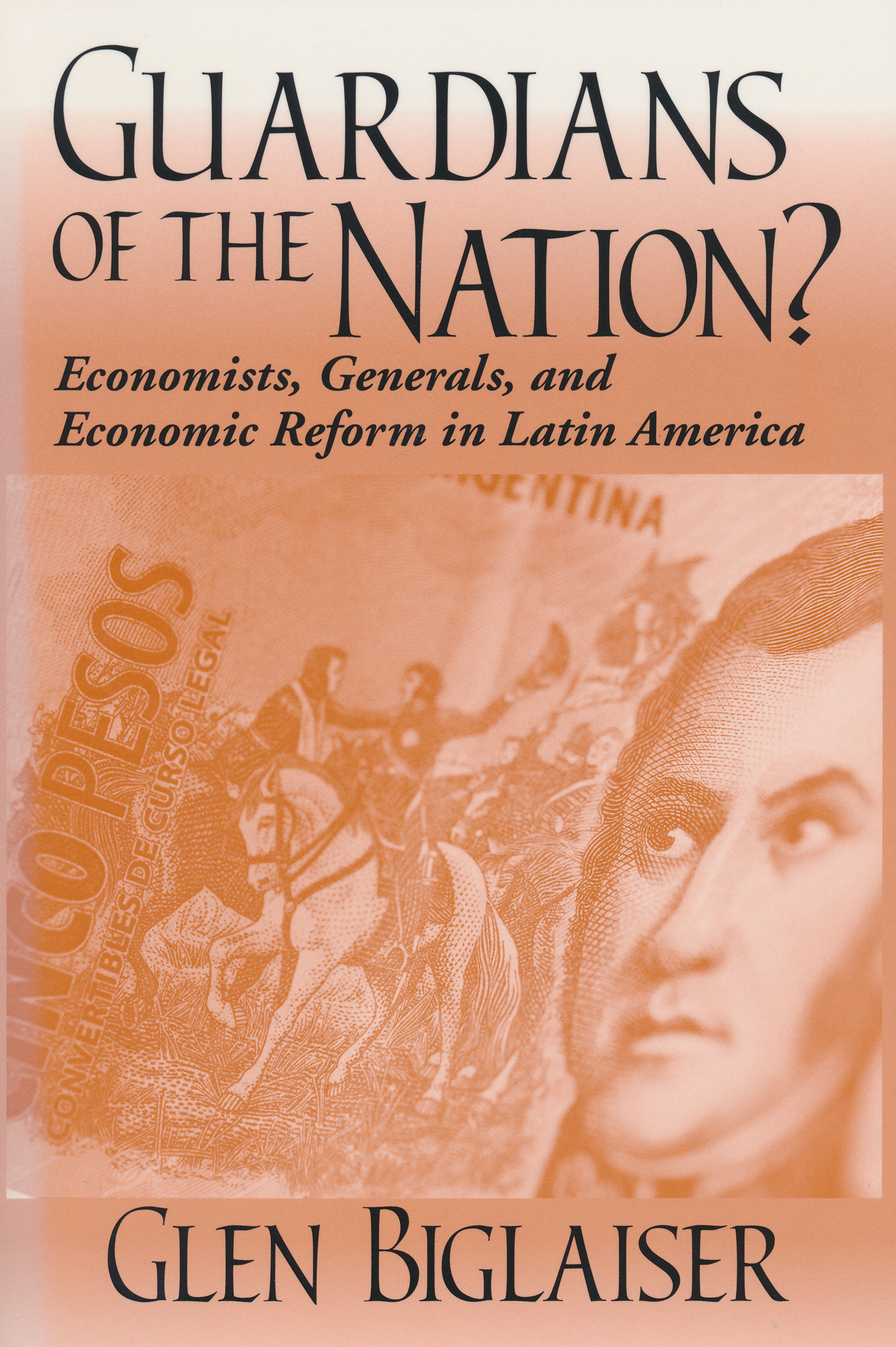
Guardians of the Nation? Central to the question of how to promote economic growth in Latin America is the role different types of regimes play in determining economic performance. Guardians of the Nation? challenges conventional wisdom regarding the expected advantages of military rule for economic growth. Glen Biglaiser explains why many military regimes in Latin America have not performed noticeably better than their democratic counterparts. Biglaiser argues that economic policy-making under military regimes is essentially an unintended by-product of the military’s strategy to retain power. Using this premise, he examines the economic performance of regimes in Argentina, Chile, and Uruguay. Biglaiser shows that the appointment of neoliberal economists occurred not because military rulers possessed inherent interest in following market-oriented policies, but because they saw the appointments as a way to solidify their power. Biglaiser’s study also depicts Pinochet’s one-man rule as unique vis-à -vis the military regimes in Argentina and Uruguay. He concludes by demonstrating that his study is also applicable for understanding economic policy choice under democratic rule, and by comparing the similarities and differences between presidential and parliamentary governments. POLITICAL SCIENCE,World,Caribbean & Latin American

Who Governs Britain? 'Jaw-dropping' Daily Telegraph 'A timely examination of how the distribution of power has shifted' Guardian Where does power lie in Britain today? Is our system of government still fit for purpose? A revelatory guide from the esteemed expert in British government and politics The British system has been radically transformed in recent decades, far more than most of us realize. As acclaimed political scientist and bestselling author Anthony King shows, this transformation lies at the heart of British politics today. Imagining - or pretending - that the British political system and Britain's place in the world have not greatly changed, our political leaders consistently promise more than they can perform. Political and economic power is now widely dispersed both inside and outside the UK, but Westminster politicians still talk the language of Attlee and Churchill. How exactly has the British system changed? Where does power now lie? In Who Governs Britain?, King offers the first assessment in many years of Britain's governing arrangements as a whole, providing much needed context for the upcoming election. POLITICAL SCIENCE,World,European
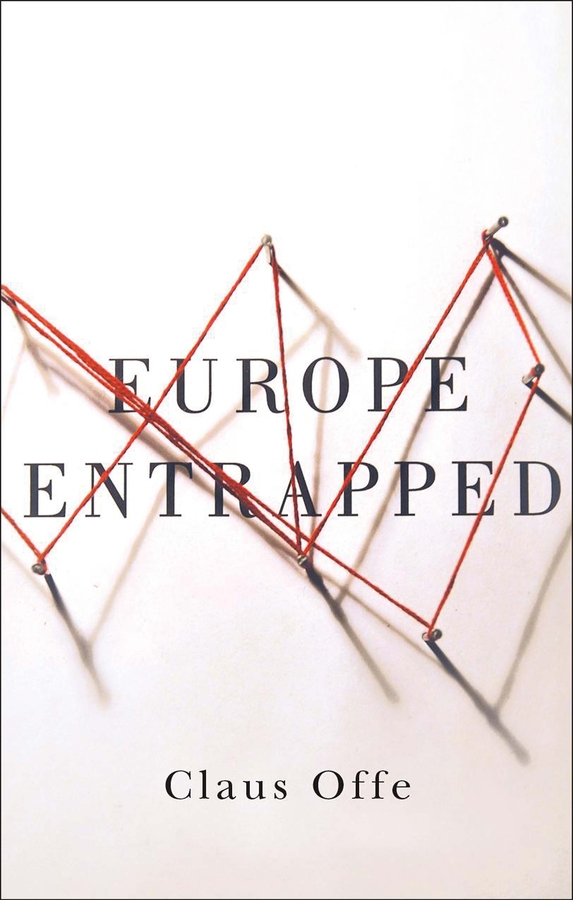
Europe Entrapped Today Europe finds itself in a crisis that casts a dark shadow over an entire generation. The seriousness of the crisis stems from one core political contradiction at the heart of the European project: namely, that what urgently needs to be done is also extremely unpopular and therefore virtually impossible to do democratically. What must be done - and almost everyone agrees in principle on the measures that would be needed to deal with the financial crisis - cannot be sold to the voting public of the core member states, which so far have been less affected by the crisis than those on the periphery, nor can the conditions that core members try to impose be easily sold to voters in the deficit countries. The European Union is therefore becoming increasingly disunited, with deepening divides between the German-dominated ‘core’ and the southern ‘periphery’, between the winners and the losers of the common currency, between the advocates of greater integration and the anti-Europeans, between the technocrats and the populists. Europe finds itself trapped by the deepening divisions that are opening up across the Continent, obstructing its ability to deal with a crisis that has already caused massive social suffering in the countries of the European periphery and is threatening to derail the very project of the European Union. In this short book, Claus Offe brings into sharp focus the central political problem that lies at the heart of the EU and shackles its ability to deal with the most serious crisis of its short history. POLITICAL SCIENCE,World,European

The European Union The essential Pelican introduction to the European Union - its history, its politics, and its role today For most of us today, 'Europe' refers to the European Union. At the centre of a seemingly never-ending crisis, the EU remains a black box, closed to public understanding. Is it a state? An empire? Is Europe ruled by Germany or by European bureaucrats? Does a single European economy exist after all these years of economic integration? And should the EU have been awarded the Nobel peace prize in 2012? Critics tell us the EU undermines democracy. Are they right? In this provocative volume, political scientist Chris Bickerton provides an answer to all these key questions and more at a time when understanding what the EU is and what it does is more important than ever before. POLITICAL SCIENCE,World,European

The Politics of Security Sector Reform Security Sector Reform (SSR) is increasingly becoming a cornerstone in international security and development cooperation. Indeed, the concept has often been seen as a panacea for many of the biggest threats to the world such as failed states, terrorism and poverty. In particular, this book focuses on the complexities of implementation of SSR across the globe and the actual and potential role for the European Union (EU) to play in SSR. As suggested in the title of the book, this involves not only opportunities, but challenges to be overcome as well. There are three core themes to this book: Policy, Policies and Practice. By presenting the themes in this particular order a greater appreciation of the influences on the process of SSR, from conception to implementation is relayed to the reader. This volume appeals to audiences interested in the EU as a global actor and the interrelationships between foreign, security, defence and development policies. POLITICAL SCIENCE,World,European

The Politics of Migration and Immigration in Europe This second edition has been completely updated to cover recent events and issues including the Syrian refugee crisis, the Paris terror attacks, the rise of right-wing political parties, and the Shengen agreement, thus continuing to provide readers with a timely and significant resource POLITICAL SCIENCE,World,European

Why Vote Leave Is it time to leave? MEP and award-winning writer Daniel Hannan makes an informed, passionate and reasoned case for a British exit from the EU ahead of the referendum. NOW with post-referendum preface. POLITICAL SCIENCE,World,European

European Union Enlargement Conditionality The book provides the first comprehensive comparative analysis of the development of EU enlargement conditionality across four different enlargement waves - the first (2004) and the second (2007) phase of the Eastern enlargement, the EU enlargement to Croatia (2013), and the ongoing enlargement round involving Turkey and the Western Balkans. POLITICAL SCIENCE,World,European

Why the UK Voted for Brexit This book studies the unprecedented decision of 23 June 2016, which saw the UK electorate vote to leave the EU, turning David Cameron’s referendum gamble into a great miscalculation. It analyzes the renegotiation that preceded the vote, before examining the campaign itself so as to understand why the government’s strategy for winning foundered. It then evaluates the implications that this decision has for the country’s international relations as well as for its domestic politics. The author’s final reflections are on the political philosophy of Brexit, which is founded on a critique of representative democracy. Yet the use of direct democracy to trigger EU withdrawal leaves the supposedly sovereign British people at an impasse. For it is up to the people’s representatives to negotiate the terms of Brexit. By engaging with a highly charged political debate in an accessible and non-partisan manner this book will appeal to a broad readership of academics, policy-makers, journalists, and interested citizens. POLITICAL SCIENCE,World,European

The End of British Politics? This book explores the crisis of the British state. Though it has been particularly apparent since the outcome of both the 2014 Scottish independence and 2016 ‘Brexit’ referendums, it stems from deep historical roots. The book traces the origins of the state to the original Act of Union of 1707 and demonstrates how different notions of British destiny - Protestant, imperial, social democratic – have held the state together at different times. The present crisis, it is argued, is due to the exhaustion of these senses of destiny. Moran shows how the United Kingdom is now held together as a militarised state prone to disastrous adventures like the invasion of Iraq, and concludes by examining some alternative futures for the state. This book will appeal to students, scholars and the general reader interested in British politics and political history. POLITICAL SCIENCE,World,European

The EU’s Transformative Power Between 1989 and 2004, the EU's conditionality for membership transformed Central and East Europe. This book demonstrates how that transformation worked in practice. The EU was able to use its massive bargaining power coercively at certain key points in the membership preparations. However, its primary method was soft power, through 'Europeanizing' the candidates into its norms and methods. This book explores in detail how the EU used its influence to control the movement of people, through both conditionality and Europeanization. POLITICAL SCIENCE,World,European

And the Weak Suffer What They Must? A #1 Sunday Times bestseller [UK] A titanic battle is being waged for Europe's integrity and soul, with the forces of reason and humanism losing out to growing irrationality, authoritarianism, and malice, promoting inequality and austerity. The whole world has a stake in a victory for rationality, liberty, democracy, and humanism. In January 2015, Yanis Varoufakis, an economics professor teaching in Austin, Texas, was elected to the Greek parliament with more votes than any other member of parliament. He was appointed finance minister and, in the whirlwind five months that followed, everything he had warned about-the perils of the euro's faulty design, the European Union's shortsighted austerity policies, financialized crony capitalism, American complicity and rising authoritarianism-was confirmed as the "troika" (the European Central Bank, International Monetary Fund, and European Commission) stonewalled his efforts to resolve Greece's economic crisis. Here, Varoufakis delivers a fresh look at the history of Europe's crisis and America's central role in it. He presents the ultimate case against austerity, proposing concrete policies for Europe that are necessary to address its crisis and avert contagion to America, China, and the rest of the world. With passionate, informative, and at times humorous prose, he warns that the implosion of an admittedly crisis-ridden and deeply irrational European monetary union should, and can, be avoided at all cost. POLITICAL SCIENCE,World,European
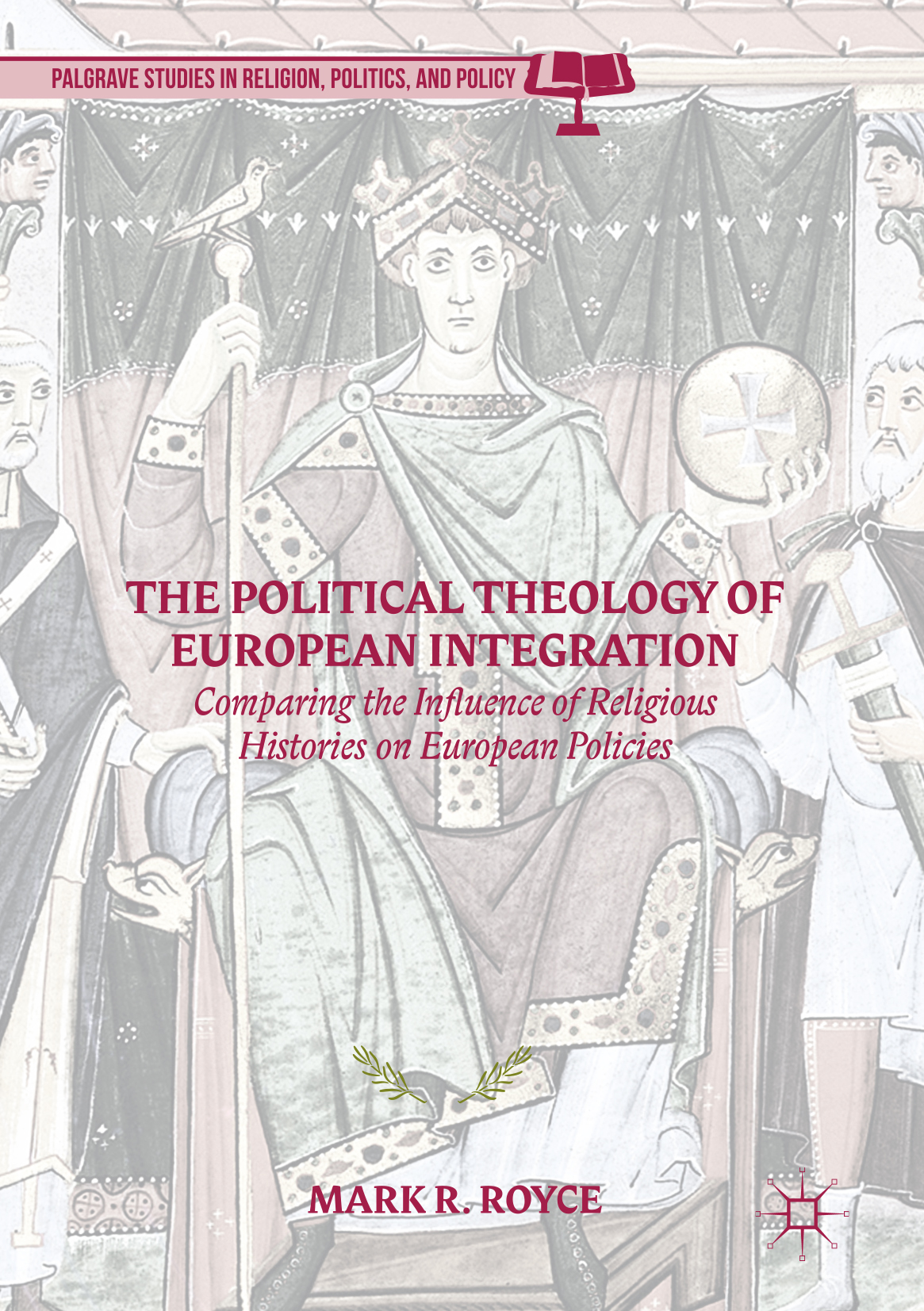
The Political Theology of European Integration This book traces the connections between diverging postwar European integration policies and intra-Christian divisions to argue that supranational integration originates from Roman Catholic internationalism, and that resistance to integration, conversely, is based in Protestantism. Royce supports this thesis through a rigorously supported historical narrative, arguing that sixteenth-century theological conflicts generated seventeenth-century constitutional solutions, which ultimately effected the political choices both for and against integration during the twentieth century. Beginning with a survey of all ecclesiastical laws of seventeen West European countries and concluding with a full discussion of the Brexit vote and emerging alternatives to the EU, this examination of the political theology surrounding the European Union will appeal to all scholars of EU politics, modern theology, religious sociology, and contemporary European history. POLITICAL SCIENCE,World,European

Voices of the UK Left This book brings together a team of specialists to explore why some left-wing politicians are able to communicate their message effectively, whereas others struggle to connect with the public. To address this question, it analyses the rhetoric and narratives employed by figures from British and Welsh Labour, the Green Party, the Scottish National Party and the radical left, as well as the anti-austerity movement. In doing so, the collection offers insights into why the performances of political actors such as Carwyn Jones and Nicola Sturgeon resonate with a wide audience, whereas some - like Jeremy Corbyn - have limited appeal beyond the party faithful. The volume provides an accessible examination of the language and ideas of the UK left, while offering a novel perspective on the challenges currently facing the Labour Party. It will therefore appeal to a wide readership, including scholars and students of rhetoric, ideology, political leadership, and British politics. POLITICAL SCIENCE,World,European
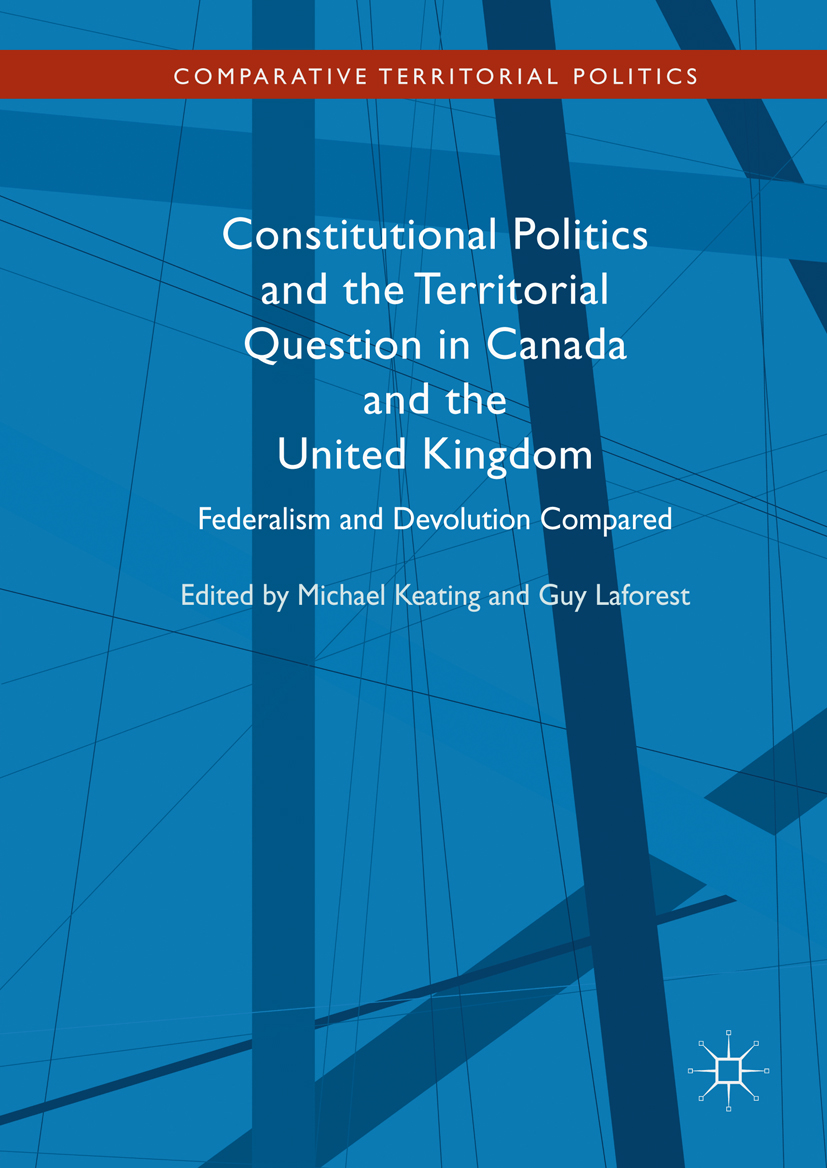
Constitutional Politics and the Territorial Question in Canada and the United Kingdom This book compares the constitutional politics in Canada and the United Kingdom – two complex, multilevel, plurinational states. While the former is federal and the latter a devolved state, the logic of both systems is similar: to combine unity with diversity. Both are facing similar challenges in a world marked by spatial rescaling, international interdependence and economic and social change. The contributors chart these challenges and the responses of the two countries, covering the meanings of federalism and devolution; the role of the courts; fiscal equalization; welfare; party politics; reform by popular referendum and citizen assemblies; and intergovernmental relations. The book will be of interest to students of federalism and multilevel government, state transformation territorial politics on both sides of the Atlantic. POLITICAL SCIENCE,World,European
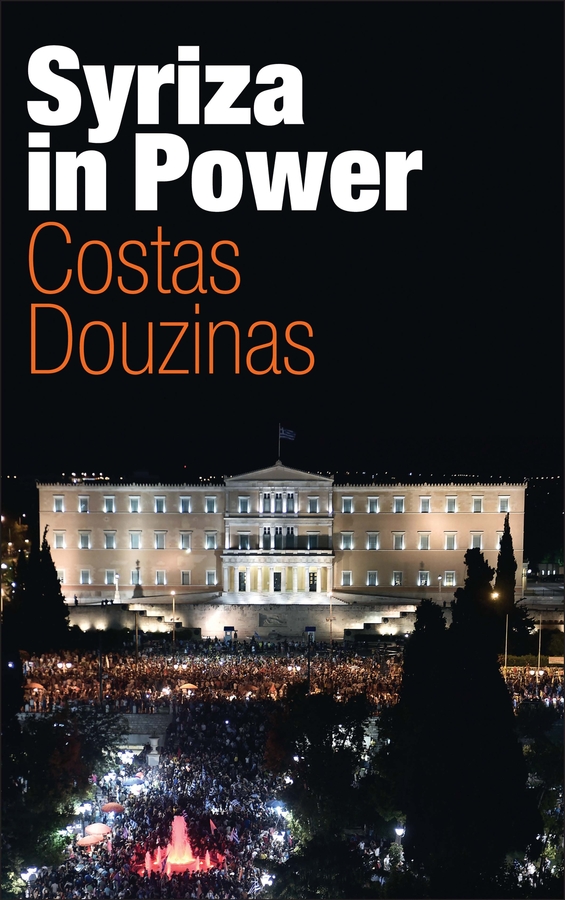
Syriza in Power Amid the turmoil of economic crisis, Greece has become the first European experiment of left rule in a sea of neoliberalism. What happens when a government of the Left, committed to social justice and the reversal of austerity, is blackmailed into following policies it has fought against and strongly opposes? What can the experience of the Syriza government tell us about the prospects for the Left in the twenty-first century? In this engaging and provocative book, Costas Douzinas uses his position as an 'accidental politician', unexpectedly propelled from academia into the world of Greek politics as a Syriza MP, to answer these urgent questions. He examines the challenges facing Syriza since its ascent to power in 2015 and draws out the theoretical and political lessons from one of the boldest and most difficult experiments in governing from the Left in an age of neoliberalism and austerity. POLITICAL SCIENCE,World,European

Islamophobia in Britain This book is concerned with the ideology of Islamophobia as a cultural racism, and argues that in order to understand its prevalence we must focus not only on what Islamophobia is, but also why diversely situated individuals and groups choose to employ its narratives and tropes. Since 2001, Muslims in Britain have been constructed as the nation’s significant ‘other’ – an internal and external enemy that threatened both social cohesion and national security. Through a consideration of a number of pertinent contemporary issues, including no-mosque campaigns, the rise of anti-Islamist social movements and the problematisation of Muslim culture, this book offers a new understanding of Islamophobia as a form of Eurocentric spatial dominance, in which those identified as Western receive a better social, economic and political ‘racial contract’, and seek to defend these privileges against real and imagined Muslim demands. POLITICAL SCIENCE,World,European
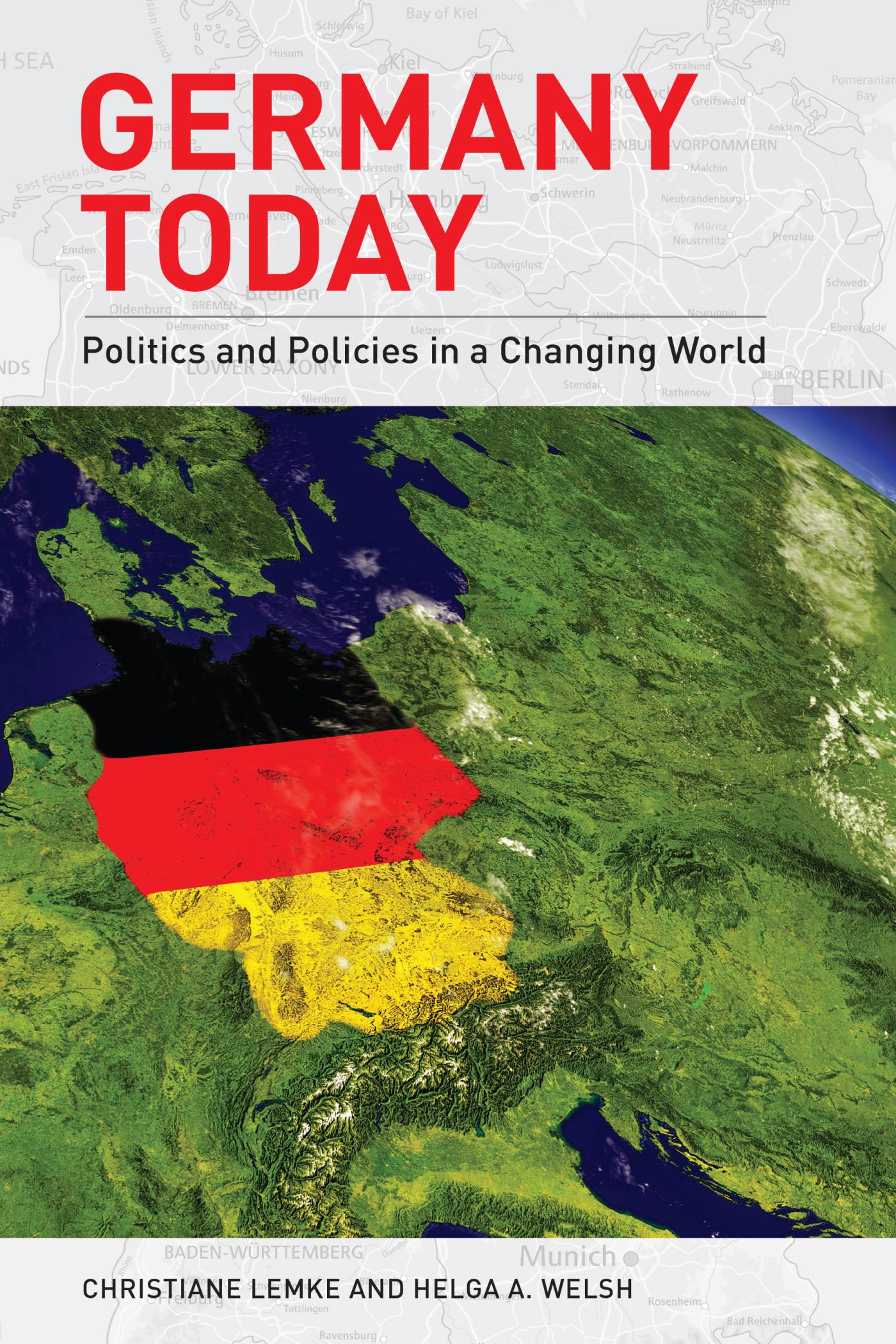
Germany Today This text analyzes the major post-unification developments that have tested and shaped the “new Germany†from a multilevel perspective. Informed by the authors’ intimate knowledge of Germany, the book offers a comprehensive, in-depth analysis of a pivotal global player at a critical economic, political, social, and environmental juncture. POLITICAL SCIENCE,World,European

Brexit and British Politics Brexit has changed everything - from our government, to our economy and principal trading relationship, to the organization of our state. This watershed moment, which surprised most observers and mobilized previously apathetic sections of the electorate, is already transforming British politics in profound and lasting ways. In this incisive book, leading analysts of UK and EU politics Geoffrey Evans and Anand Menon step back from the immediacy and hyperbole of the Referendum to explain what happened on 23 June 2016, and why. Brexit, they argue, was the product of both long-term dissatisfaction with the EU and a gradual breakdown in the relationship between parties and voters that spawned detachment, disinterest and disenchantment. Exploring its subsequent impact on the June 2017 General Election, they reveal the extent to which Brexit has shattered the contemporary equilibrium of British politics. These reverberations will continue to be felt for a very long time and could pose a real danger to the health of British democracy if the government fails to deliver on the promises linked to Brexit. POLITICAL SCIENCE,World,European

The EU's Power in Inter-Organisational Relations This book studies inter-organisational relations from a new angle: power. Drawing on examples that highlight how the EU relates to NATO and to the UN, it shows how consequential inter-organisational relations are for the functioning and nature of the organisations, and how important it is to detect the forms of power exerted in these relations. Power, for international organisations, is above all about relevance. In an era when the legitimacy and role of international organisations is increasingly questioned, the organisations have a growing concern for ensuring their continued relevance. Subsequently, the management of relevance is a central part of inter-organisational relations and becomes visible in the way organisations handle questions about their tasks, hierarchies and image. Clear and accessible, the book will appeal both to the growing scholarly community working on inter-organisational relations and to a variety of audiences including practitioners and scholars outside the field of international relations. POLITICAL SCIENCE,World,European

Europe's Crises Today, the European Union is facing a crisis as serious as anything it has experienced since its origins more than half a century ago. What makes this so serious is that it is not a single crisis but rather multiple crises – the euro crisis, the migration/refugee crisis, Brexit, etc. – that overlap and reinforce one another, creating a cumulative array of challenges that threatens the very survival of the EU. For the first time in its history, there is a real risk that the EU could break up. This volume brings together sociologists, economists and political scientists from around Europe to shed light on how the EU got into this predicament. It argues that the multiple crises that have plagued the European Union in the last decade stem to a large extent from flaws in its construction and that these flaws are consequences of the political processes that led to the formation of the EU – in other words, the decisions that made possible the development of the EU created the conditions for the multiple crises it experiences today. This timely and wide-ranging book on one of the most important issues of our time will be of great interest to students and scholars in the social sciences, to politicians and policy-makers and to anyone concerned with Europe and its future. POLITICAL SCIENCE,World,European
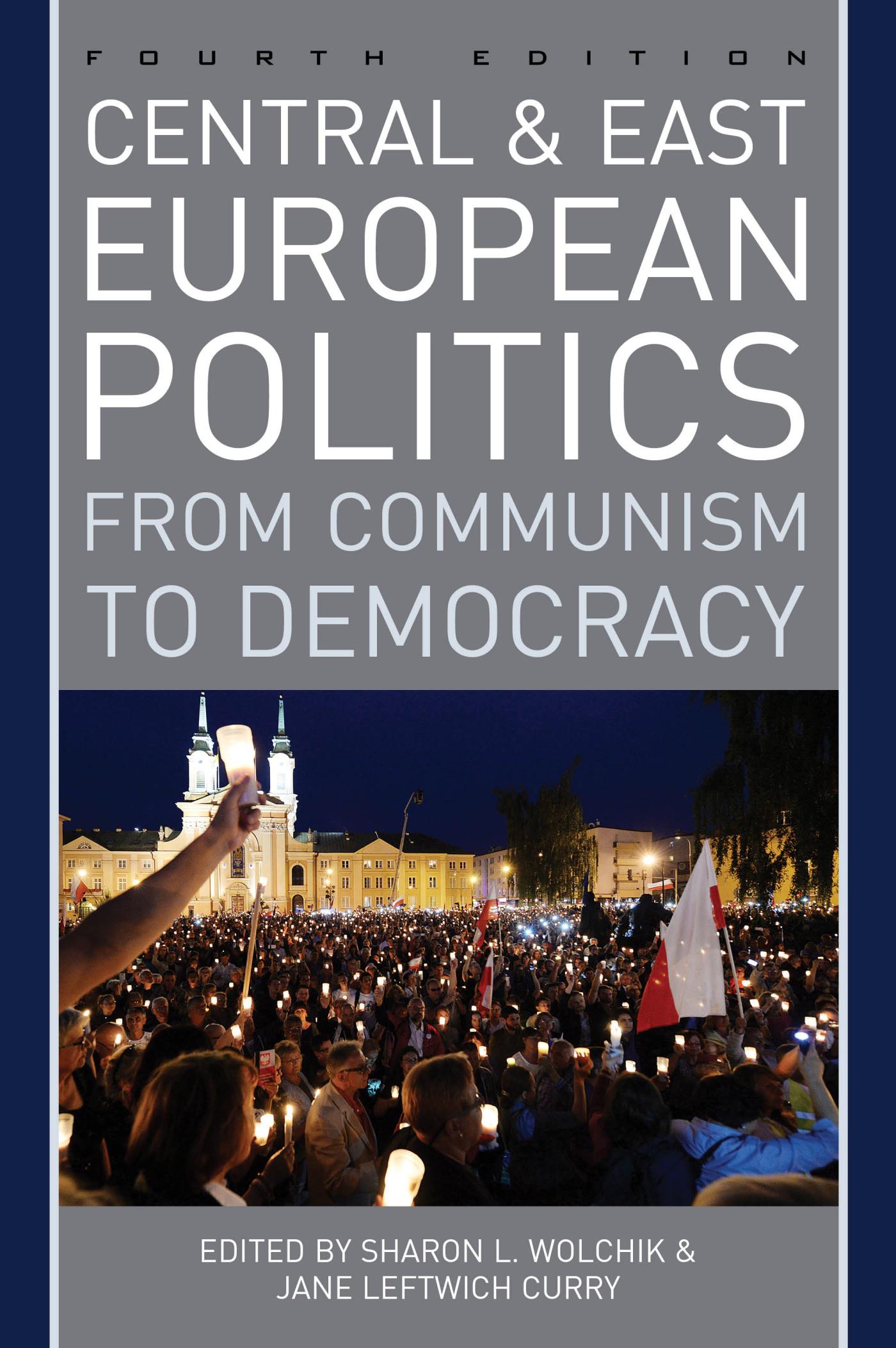
Central and East European Politics Now in a fully updated edition, this essential text explores the other half of Europe—the new and future members of the European Union along with the problems and potential they bring to the region and to the world stage. Clear and comprehensive, it offers an authoritative and up-to-date analysis of the transformations and realities in Central and Eastern Europe, the Baltics, and Ukraine. POLITICAL SCIENCE,World,European
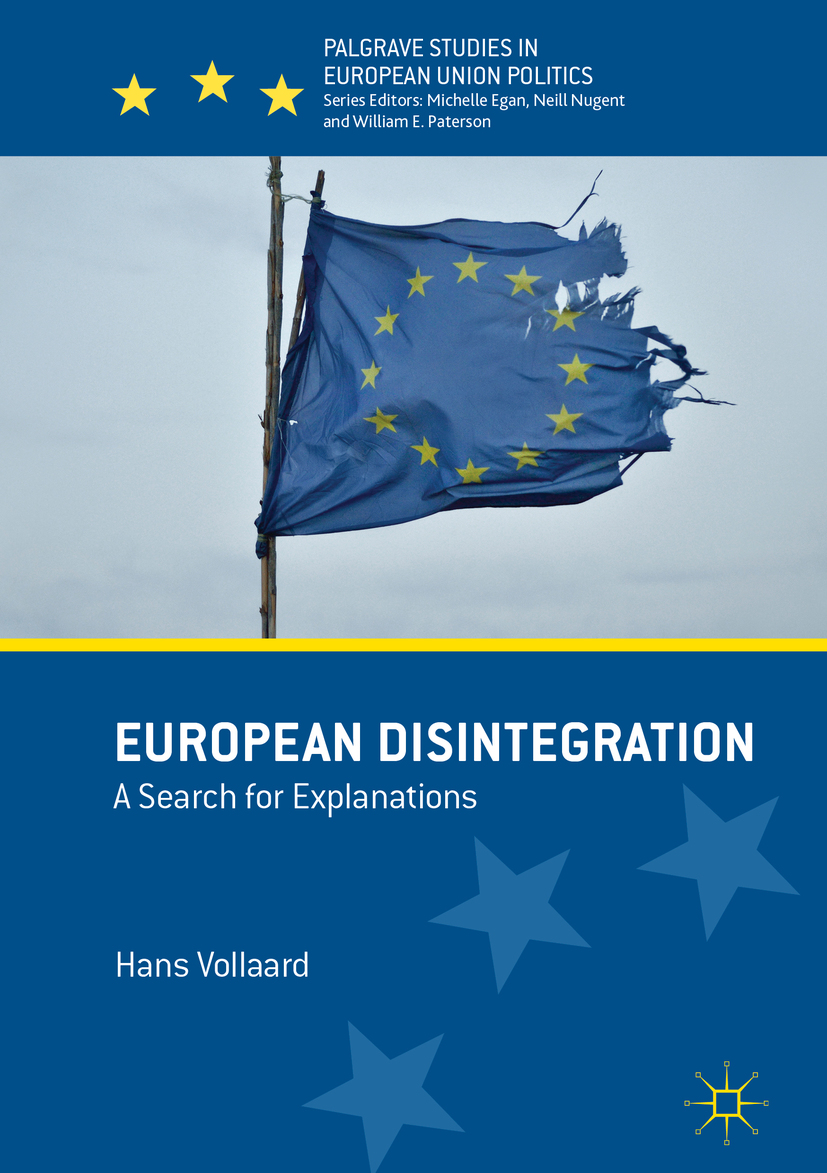
European Disintegration This book accounts for whether and how the path of the European Union (EU) has developed towards potential disintegration. These questions have become particularly relevant since the outbreak of the debt crises in the Eurozone and the Brexit referendum. The author critically subverts theories of European integration and analyses the rise and fall of federations, empires and states in a comparative perspective. The most promising theory presented here indicates that Brexit is not likely to be followed by other member states leaving the EU. Nevertheless, the EU has been undermined from within as it cannot adequately address Eurosceptic dissatisfaction from both the left and right. This book is an essential read for everyone interested in the EU and its future. POLITICAL SCIENCE,World,European
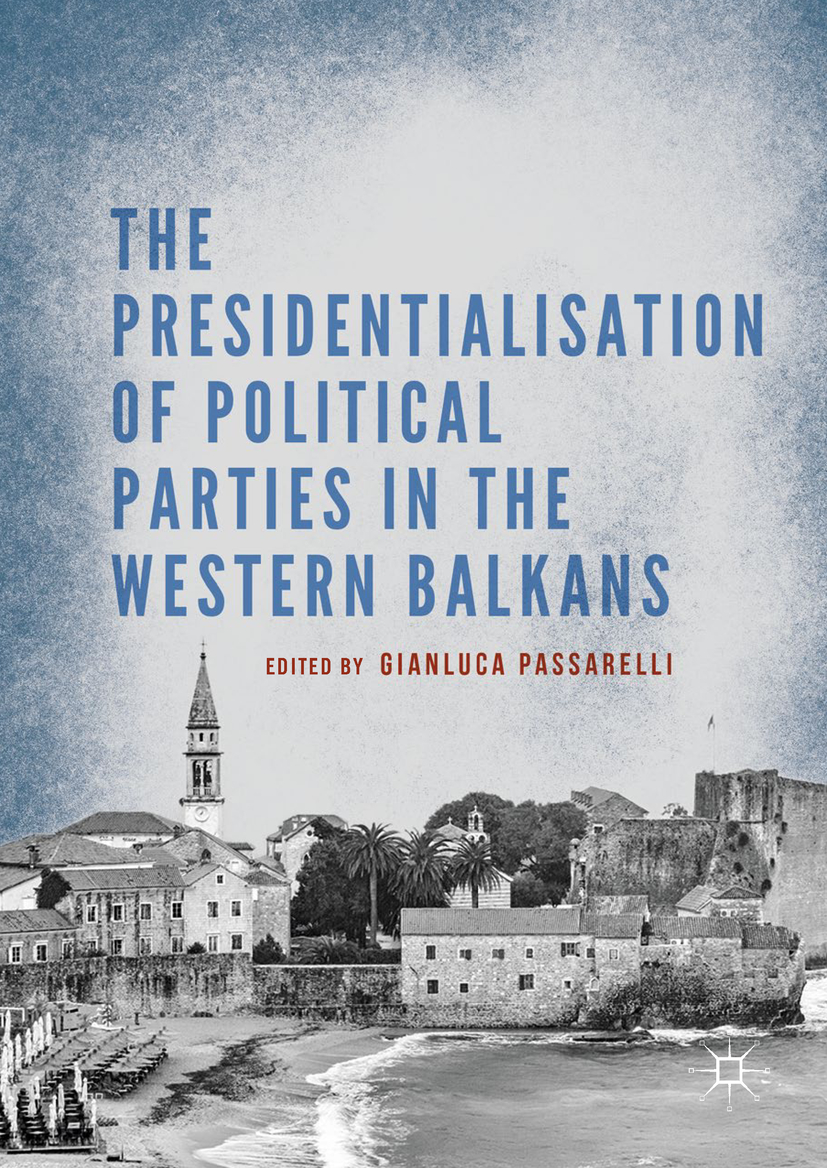
The Presidentialisation of Political Parties in the Western Balkans This book examines the process of presidentialisation of political parties in the Western Balkans. The Western Balkan countries deserve to be analysed in a comparative perspective due to their distinctive features in terms of processes of democratization, forms of government and institutional assets, the presence of social cleavages (religious, linguistic, ethnic), and, of course, the nature of political parties which differs from other European cases, especially in terms of origins, organization and structure. However, Western Balkan political parties do show certain similarities with other West European cases where power is centralised and held by the parties’ leadership. The book ultimately attempts to test whether and to what extent the influence of institutional variables affects the level of presidentialisation of political parties, also considering the parties’ organization features. POLITICAL SCIENCE,World,European

Germany's Difficult Passage to Modernity Germany's institutional anatomy, its norms, and the spirits that animate it can only be properly understood if one takes into account such factors as its economic power and central position within Europe. This volume traces the difficult passage of German society to modernity, offering new perspectives on the "German question," largely characterized by the absence of key ideological underpinnings of democracy in the early modern period and a constitutional exceptionalism on the eve of the 20th century. The essays describe the organizational infrastructure and behavioral norms that account for the success of Germany's postwar economy and polity, but also register the tensions between the increasingly individualist outlook of post-1968 Germans and the country's highly organized and ritualistic decision-making structures, which often severely test the democratic foundations of the republic. However, Germany is not unique in its efforts to find a balance between traditional and modern forces that have shaped its history. This volume demonstrates that Germany's experience, past and present, teaches broader lessons that speak to the central concerns of our time: what are the historical precursors of and vital attitudes towards democracy? How much structural variation will be feasible in political economies embedded in Europe after the introduction of the Euro and in the context of economic and other globalization? The considerable insights into these questions provided by this volume celebrate the inspiration given to colleagues and students who have worked with Andrei S. Markovits, to whom it is dedicated. POLITICAL SCIENCE,World,European

Trust Us In Scandinavia, there is separation in the electorate between those who embrace diversity and those who wish for tighter bonds between people and nation. This book focuses on three nationalist populist parties in Scandinavia—the Sweden Democrats, the Progress Party in Norway, and the Danish People’s Party. In order to affect domestic politics by addressing this conflict of diversity versus homogeneity, these parties must enter the national parliament while earning the nation’s trust. Of the three, the Sweden Democrats have yet to earn the trust of the mainstream, leading to polarized and emotionally driven public debate that raises the question of national identity and what is understood as the common man. POLITICAL SCIENCE,World,European

The Merkel Republic Chancellor Angela Merkel has dominated German and European politics for almost a decade. Her stellar reputation, sound political and economic management, and popularity inside of Germany resulted in one of the most decisive electoral victories for her conservative parties in postwar Germany—the country can rightfully be deemed the Merkel Republic. Bringing together German politics experts from both sides of the Atlantic, this volume addresses the campaign, results, and consequences of the 2013 Bundestag election. Chapters delve into a diverse array of themes, including immigrant-origin and women candidates, the fate of the small parties, and the prospects for the SPD, the new coalition partner, as well as more general structural trends like the Europeanization and cosmopolitanization of German politics. POLITICAL SCIENCE,World,European

Journey into Europe An unprecedented, richly, detailed, and clear-eyed exploration of Islam in European history and civilization Tensions over Islam were escalating in Europe even before 9/11. Since then, repeated episodes of terrorism together with the refugee crisis have dramatically increased the divide between the majority population and Muslim communities, pushing the debate well beyond concerns over language and female dress. Meanwhile, the parallel rise of right-wing, nationalist political parties throughout the continent, often espousing anti-Muslim rhetoric, has shaken the foundation of the European Union to its very core. Many Europeans see Islam as an alien, even barbaric force that threatens to overwhelm them and their societies. Muslims, by contrast, struggle to find a place in Europe in the face of increasing intolerance. In tandem, anti-Semitism and other forms of discrimination cause many on the continent to feel unwelcome in their European homes. Akbar Ahmed, an internationally renowned Islamic scholar, traveled across Europe over the course of four years with his team of researchers and interviewed Muslims and non-Muslims from all walks of life to investigate questions of Islam, immigration, and identity. They spoke with some of Europe’s most prominent figures, including presidents and prime ministers, archbishops, chief rabbis, grand muftis, heads of right-wing parties, and everyday Europeans from a variety of backgrounds. Their findings reveal a story of the place of Islam in European history and civilization that is more interwoven and complex than the reader might imagine, while exposing both the misunderstandings and the opportunities for Europe and its Muslim communities to improve their relationship. Along with an analysis of what has gone wrong and why, this urgent study, the fourth in a quartet examining relations between the West and the Muslim world, features recommendations for promoting integration and pluralism in the twenty-first century. POLITICAL SCIENCE,World,European
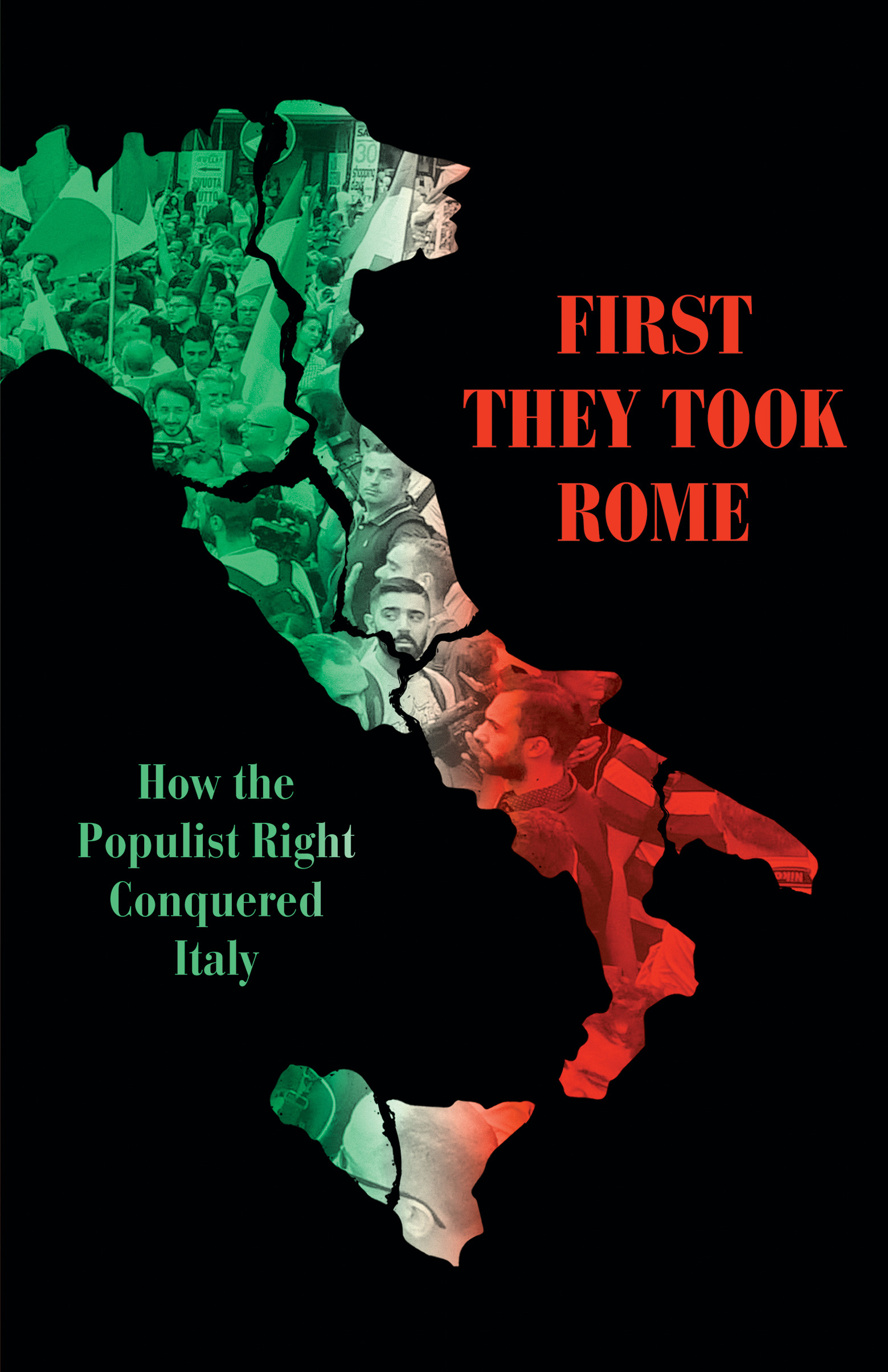
First They Took Rome Italy’s political disaster under a microscope There is little that hasn’t gone wrong for Italy in the last three decades. Economic growth has flatlined, infrastructure has crumbled, and out-of-work youth find their futures stuck on hold. These woes have been reflected in the country’s politics, from Silvio Berlusconi’s scandals to the rise of the far right. Many commentators blame Italy’s malaise on cultural ills—pointing to the corruption of public life or a supposedly endemic backwardness. In this reading, Italy has failed to converge with the neoliberal reforms mounted by other European countries, leaving it to trail behind the rest of the world. First They Took Rome offers a different perspective: Italy isn’t failing to keep up with its international peers but farther along the same path of decline they are following. In the 1980s, Italy boasted the West’s strongest Communist Party; today, social solidarity is collapsing, working people feel ever more atomized, and democratic institutions grow increasingly hollow. Studying the rise of forces like Matteo Salvini’s Lega, this book shows how the populist right drew on a deep well of social despair, ignored by the liberal centre. Italy’s recent history is a warning from the future—the story of a collapse of public life that risks spreading across the West. POLITICAL SCIENCE,World,European
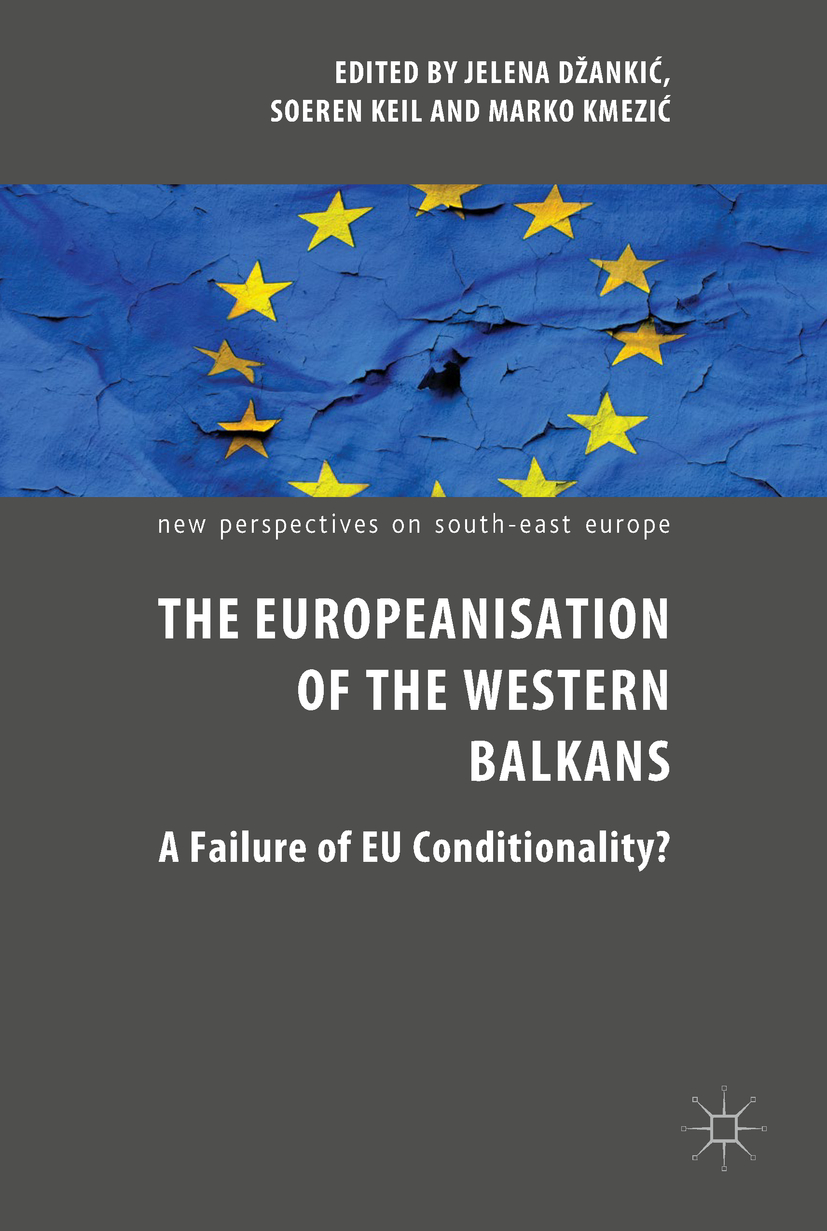
The Europeanisation of the Western Balkans This volume casts a fresh look on how the political spaces of the Western Balkan states (Croatia, Bosnia and Herzegovina, Serbia, Montenegro, Kosovo, Macedonia and Albania) are shaped, governed and transformed during the EU accession process. The contributors argue that EU conditionality in the Western Balkans does not work ‘effectively’ in terms of social change because rule transfer remains a ‘contested’ business, due to veto-players on the ground and strong legacies of the past. The volume examines specific policy areas, salient in the enlargement process and to a different degree incorporated in the accession criteria, as well as EU foreign policy in the spheres of post-conflict stabilisation, democratization and the rule of law promotion. POLITICAL SCIENCE,World,European
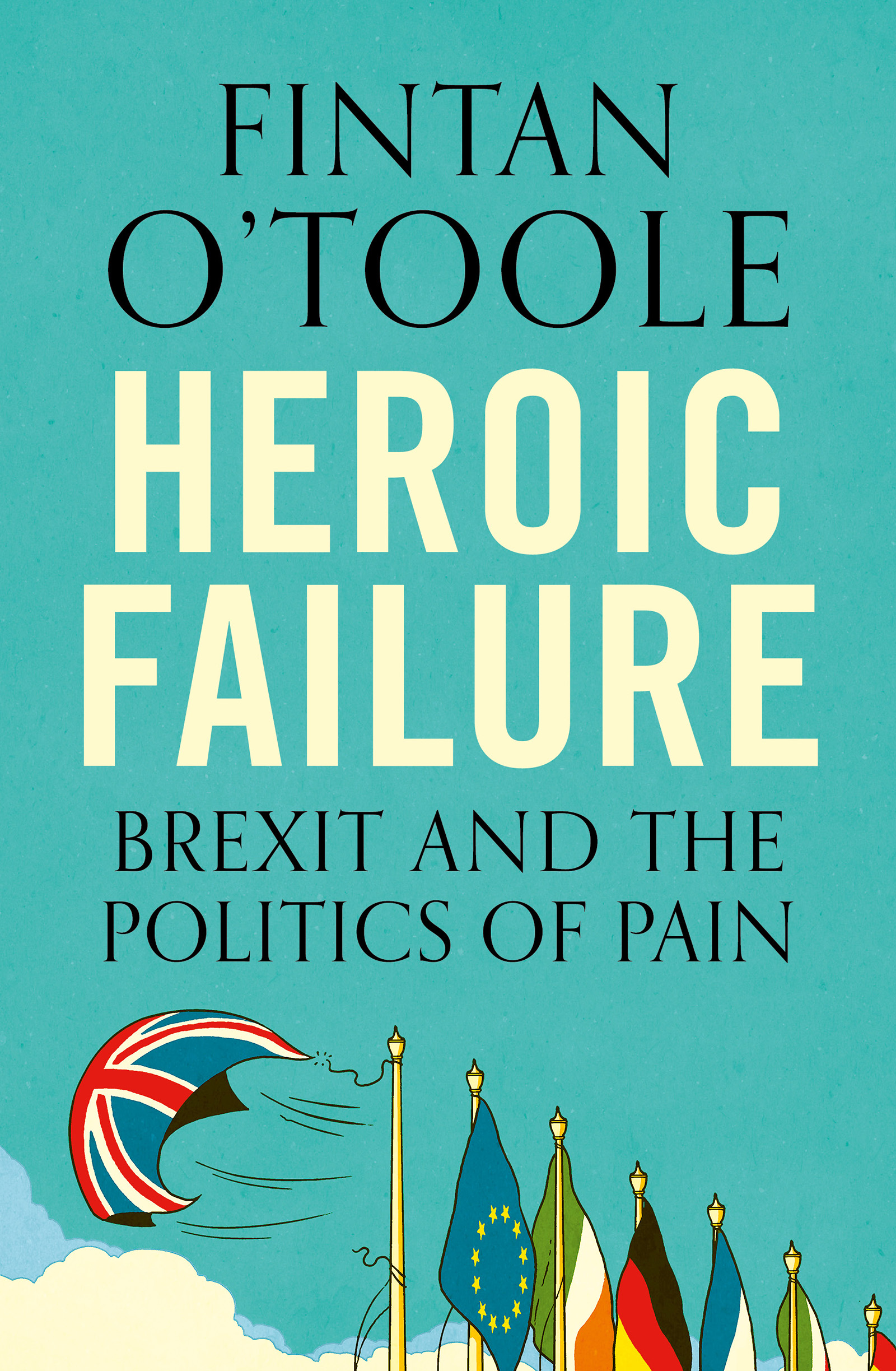
Heroic Failure A mordantly funny and perceptive book about the act of national self-harm known as Brexit. A great democratic country tears itself apart, and engages in the dangerous pleasures of national masochism. POLITICAL SCIENCE,World,European
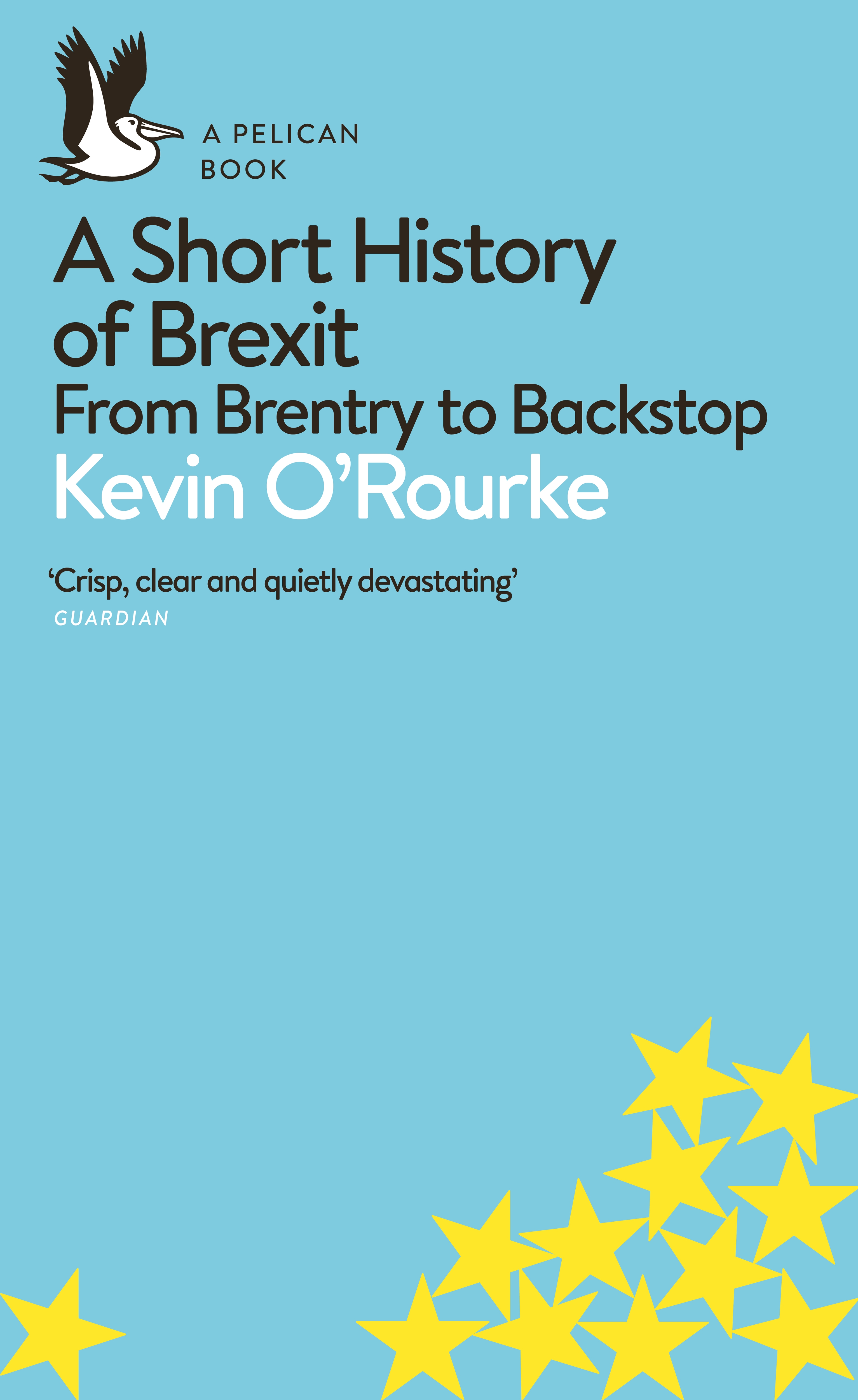
A Short History of Brexit A succinct, expert guide to how we got to Brexit After all the debates, manoeuvrings, recriminations and exaltations, Brexit is upon us. But, as Kevin O'Rourke writes, Brexit did not emerge out of nowhere: it is the culmination of events that have been under way for decades and have historical roots stretching back well beyond that. Brexit has a history. O'Rourke, one of the leading economic historians of his generation, explains not only how British attitudes to Europe have evolved, but also how the EU's history explains why it operates as it does today - and how that history has shaped the ways in which it has responded to Brexit. Why are the economics, the politics and the history so tightly woven together? Crucially, he also explains why the question of the Irish border is not just one of customs and trade, but for the EU goes to the heart of what it is about. The way in which British, Irish and European histories continue to interact with each other will shape the future of Brexit - and of the continent. Calm and lucid, A Short History of Brexit rises above the usual fray of discussions to provide fresh perspectives and understanding of the most momentous political and economic change in Britain and the EU for decades. POLITICAL SCIENCE,World,European
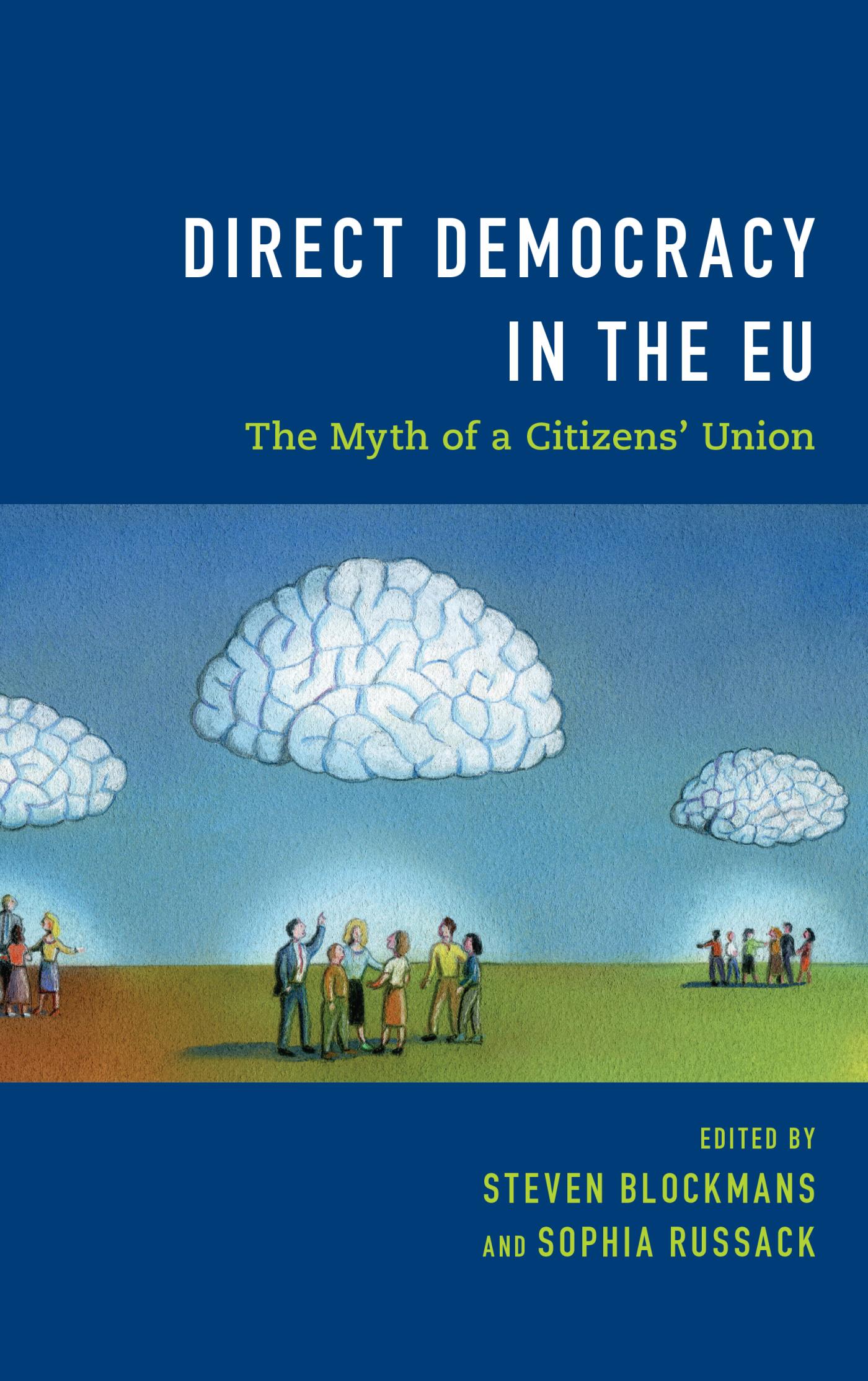
Direct Democracy in the EU This book is concerned with the two-pronged question of how the relationship between citizens, the state and EU institutions has changed, and how direct democratic participation can be improved in a multi-layered Union. POLITICAL SCIENCE,World,European

Contemporary Russian Politics Vladimir Putin’s return to the Kremlin for a fourth presidential term in 2018 has seen Russian democracy weaken further and Russia’s relations with the West deteriorate seriously. Yet, within Russia, Putin’s position remains unchallenged and his foreign policy battles have received widespread public support. But is Putin as safe as his approval ratings lead us to believe? And how secure is the regime that he heads? In this new book, Neil Robinson places contemporary Russian politics in historical perspective to argue that Putin’s regime has not overcome the problems that underpinned the momentous changes in twentieth-century Russian history when the country veered from tsarism to Soviet rule to post-communist chaos. The first part of the book, outlining why crises have been perennial problems for Russia, is followed by an exploration of contemporary Russian political institutions and policy to show how Putin has stabilised Russian politics. But, while Putin’s achievements as a politician have been considerable in strengthening his personal position, they have not dealt successfully with the enduring problem of the Russian state’s functionality. Like other Russian rulers, Putin has been much better at establishing a political system that supports his rule than he has at building up a state that can deliver material wealth and protection to the Russian people. As a result, Robinson argues, Russia has been and remains vulnerable to political crisis and regime change. POLITICAL SCIENCE,World,European

The British Constitution Resettled Adopting a political constitutionalist view of the British constitution, this book critically explores the history of legal and political thought on parliamentary sovereignty in the UK. It argues that EU membership strongly unsettled the historical precedents underpinning UK parliamentary sovereignty. Successive governments adopted practices which, although preserving fundamental legal rules, were at odds with past precedents. The author uses three key EU case studies – the financial transactions tax, freedom of movement of persons, and the working time directive – to illustrate that since 1973 the UK incorporated EU institutions which unsettled those precedents. The book further shows that the parliament’s place since the referendum on Brexit in June 2016 and the scrutinising of the terms of the withdrawal agreement constitute an enhanced, new constitutional resettlement, and a realignment of parliament with the historical precedent of consent and its sovereignty. POLITICAL SCIENCE,World,European
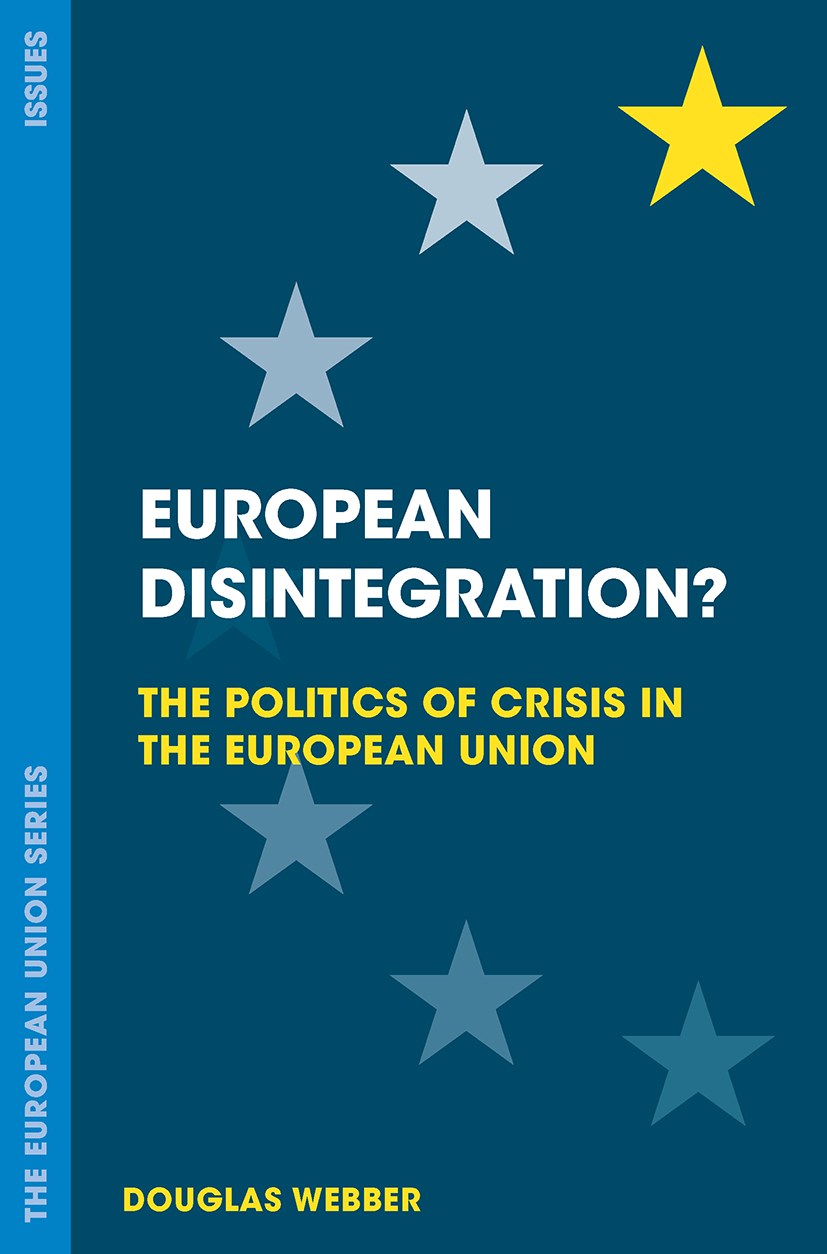
European Disintegration? This timely text provides a concise and readable assessment of the dynamics, character and consequences of European disintegration. It sets Europe's current crises in historical context and gives a clear explanatory framework for understanding contemporary dynamics. POLITICAL SCIENCE,World,European
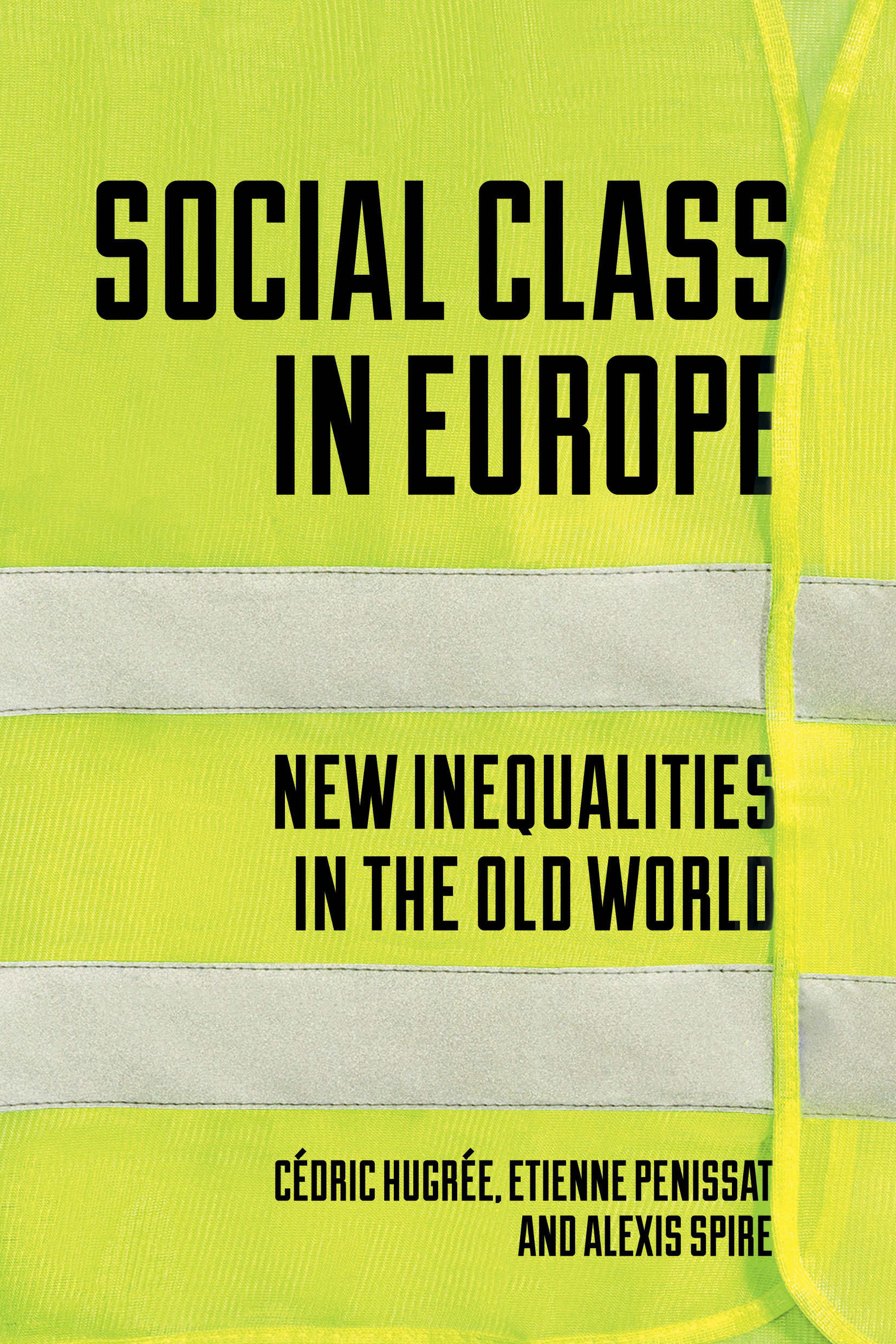
Social Class in Europe Mapping the class divisions that run throughout Europe Over the last ten years - especially with the 'no' votes in the French and Dutch referendums in 2010, and the victory for Brexit in 2016 - the issue of Europe has been placed at the centre of major political conflicts. Each of these crises has revealed profound splits in society, which are represented in terms of an opposition between those countries on the losing and those on the winning sides of globalisation. Inequalities beyond those between nations are critically absent from the debate. Based on major European statistical surveys, the new research in this work presents a map of social classes inspired by Pierre Bourdieu's sociology. It reveals the common features of the working class, the intermediate class and the privileged class in Europe. National features combine with social inequalities, through an account of the social distance between specific groups in nations in the North and in the countries of the South and East of Europe. The book ends with a reflection on the conditions that would be required for the emergence of a Europe-wide social movement. POLITICAL SCIENCE,World,European
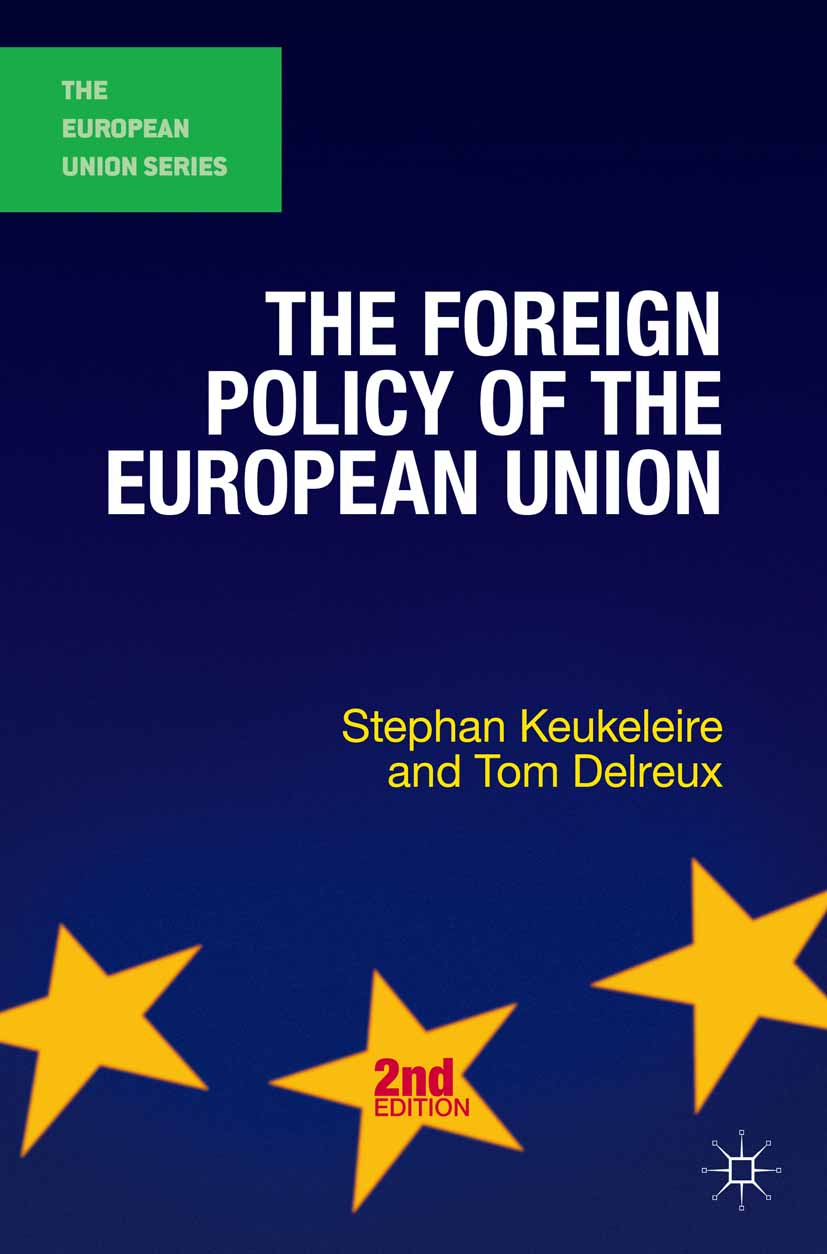
The Foreign Policy of the European Union This authoritative textbook gives a comprehensive account of the European Union's foreign policy. Going beyond the typical focus on the Common Foreign and Security Policy and Common Security and Defence Policy, Keukeleire and Delreux demonstrate the scope and diversity of the EU's foreign policy and show how areas such as trade, development, environment and energy are inextricable elements of it. The book examines the EU's key foreign relations – with its neighbourhood, with the US, China and Russia, and with the emerging powers – and argues that the EU's foreign policy needs to be understood not only as a response to crises and conflicts, but also as a means of shaping international structures and influencing long-term processes. Up to date, jargon-free and supported by its own website, this systematic and innovative appraisal of this key policy area is suitable for undergraduate and postgraduate students of EU Foreign Policy. For supporting materials, please visit the comprehensive online resource guide 'Exploring EU Foreign Policy' at www.eufp.eu POLITICAL SCIENCE,World,European

Understanding the European Union The 7th edition of this best-selling textbook provides a broad-ranging but concise introduction to the EU, covering all major aspects of the European project. This edition takes full account of the current challenges faced by the EU, including the ongoing difficulties in the Eurozone and the rise of euroscepticism, which culminated spectacularly in Britain’s decision to leave the Union in 2016. Fully updated throughout, McCormick continues to clearly and succinctly cover the history and institutions of the EU; the underlying principles of European integration; the impact of the EU on its member states and citizens; and the dynamics and effects of EU policies. Going beyond simplifying and summarising key points, McCormick also covers the nuances of principles, politics and policies that are often lost in concise introductory texts. While this text would naturally suit Political Science and International Relations students, McCormick realises that the EU is both a global political actor and the wealthiest marketplace in the world, which means the EU must be studied from multiple disciplinary persepctives. This textbook is packed with pedagogical features and written with minimal jargon and in interdisciplinary terms so as to be accessible for those with no prior understanding of the EU, enabling both Politics and International Relations students and students of other disciplines to have a refined understanding on the EU. POLITICAL SCIENCE,World,European
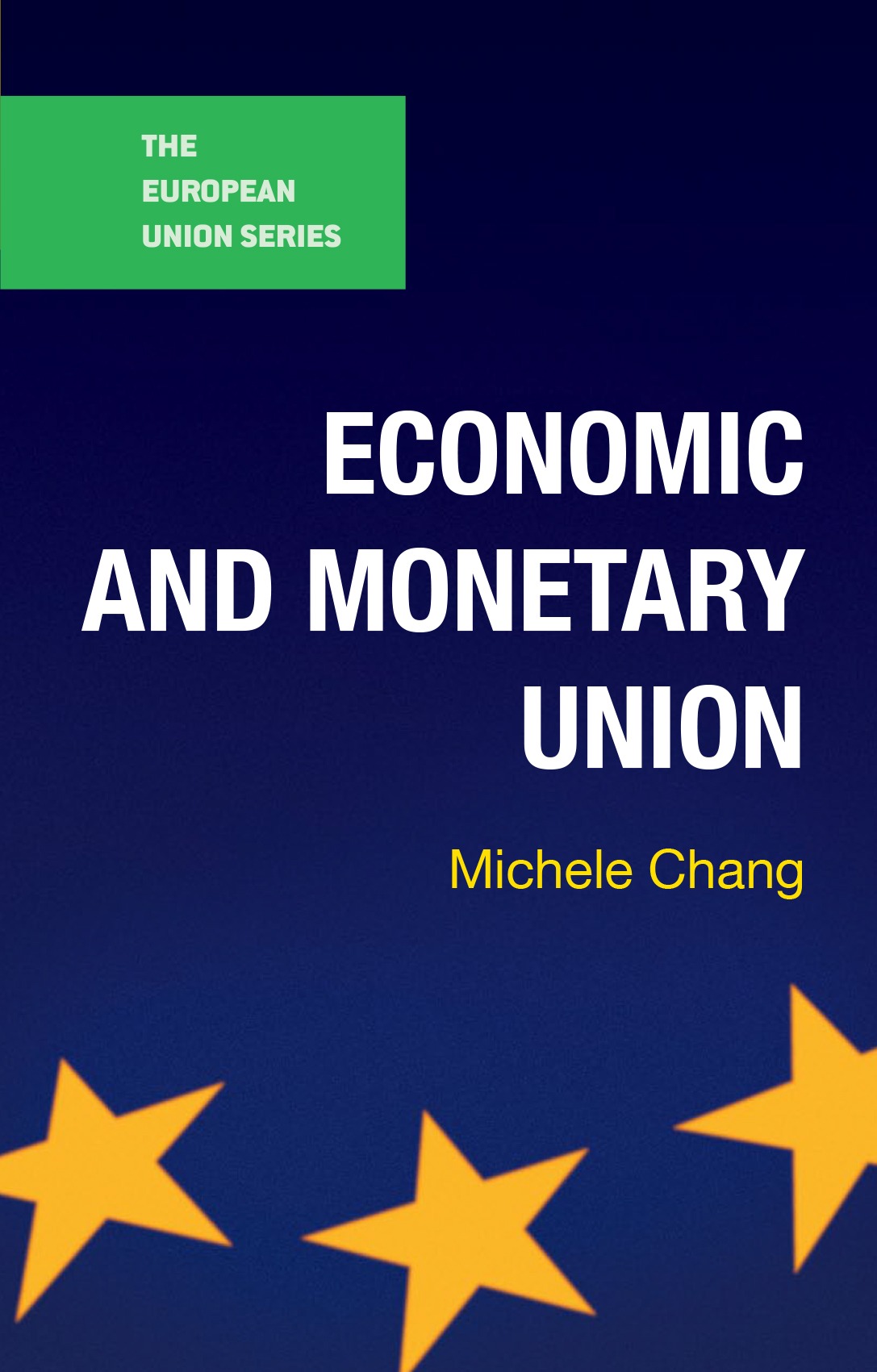
Economic and Monetary Union This accessible introductory text provides a comprehensive and accessible account of the evolution of the Eurozone, from its beginnings in fixed exchange rate systems through to the aftermath of the sovereign debt crisis. It examines why the EMU was created, what went wrong to bring about the global financial crisis, and why countries were affected so differently. It assesses the impact of monetary union both in Europe and beyond and evaluates the prospects for the Euro as an international currency. Recognising that political union has long been seen as part of monetary integration, and that Eurozone membership often impacts domestic policy, Chang widens the scope of her evaluation to include consider effects and developments that are not purely economic in scope. Using theories drawn from economics and political science, this book provides students with an up-to-date analysis of the recent reforms undertaken, grounded in a long-term perspective of the trajectory of European integration. As well as suiting upper-level undergraduate and Master's courses on European Monetary Union, this text is beneficial for students of Politics, International Relations and European Studies on more general courses to foster an understanding of the impact of the EMU on the wider functioning of the EU. The text is filled with figures, maps, timelines and other pedagogical features to ensure this topic accessible to students of all levels. POLITICAL SCIENCE,World,European

The Government and Politics of the European Union The definitive textbook on EU politics and governance, now in its 8th edition, has been thoroughly updated throughout to take into account the ongoing developments and evolution of the EU. Major changes, recent developments, and the major crises that have befallen the union in recent times are analysed within this context. This includes eurozone crisis, the migration crisis, and the UK’s decision to leave the EU. Acclaimed author and academic Neill Nugent has written a comprehensive text, enabling students with no prior knowledge of the EU to master the subject. By detailing the historical evolution of European integration, Nugent gives the necessary context to his exhaustive analysis of policies, process, institutions and treaties. This has grown to include two new chapters on Member State Relations and Interest Representation. The final section considers concepts and theories with EU studies, providing a succinct, accessible introduction to theory, which can be read as standalone chapters. Completely redesigned and updated throughout with a new structure to increase readability and packed with numerous pedagogical features -document excerpts, case studies, maps figures - and supported by a fully stocked companion website with resources for both students and lecturers, this text is an essential for students new to EU studies. POLITICAL SCIENCE,World,European

Key Controversies in European Integration Since its inception the European Union has been a fiercely contested and politically divisive project. In recent years, controversial issues such as EU enlargement, the ratification of the Lisbon Treaty, and the fallout from the Eurozone crisis have tested the EU to its limits and divided public opinion in the process. This innovative volume brings together leading scholars from around the world to debate the nature, current state and future of European integration. The contributors represent the whole spectrum of thinking about the European Union, ranging from pro-European to openly Eurosceptic perspectives. Within the book, chapters present two opposing perspectives on a wide range of controversies. Among the issues discussed are: how efficient is the European Union? Has the European project been a success? Will the Eurozone survive in its present state? And can the EU tame big finance? Guaranteed to illuminate as well as spark debate, this text provides an engaging and incisive overview of the most important issues in contemporary EU politics. POLITICAL SCIENCE,World,European
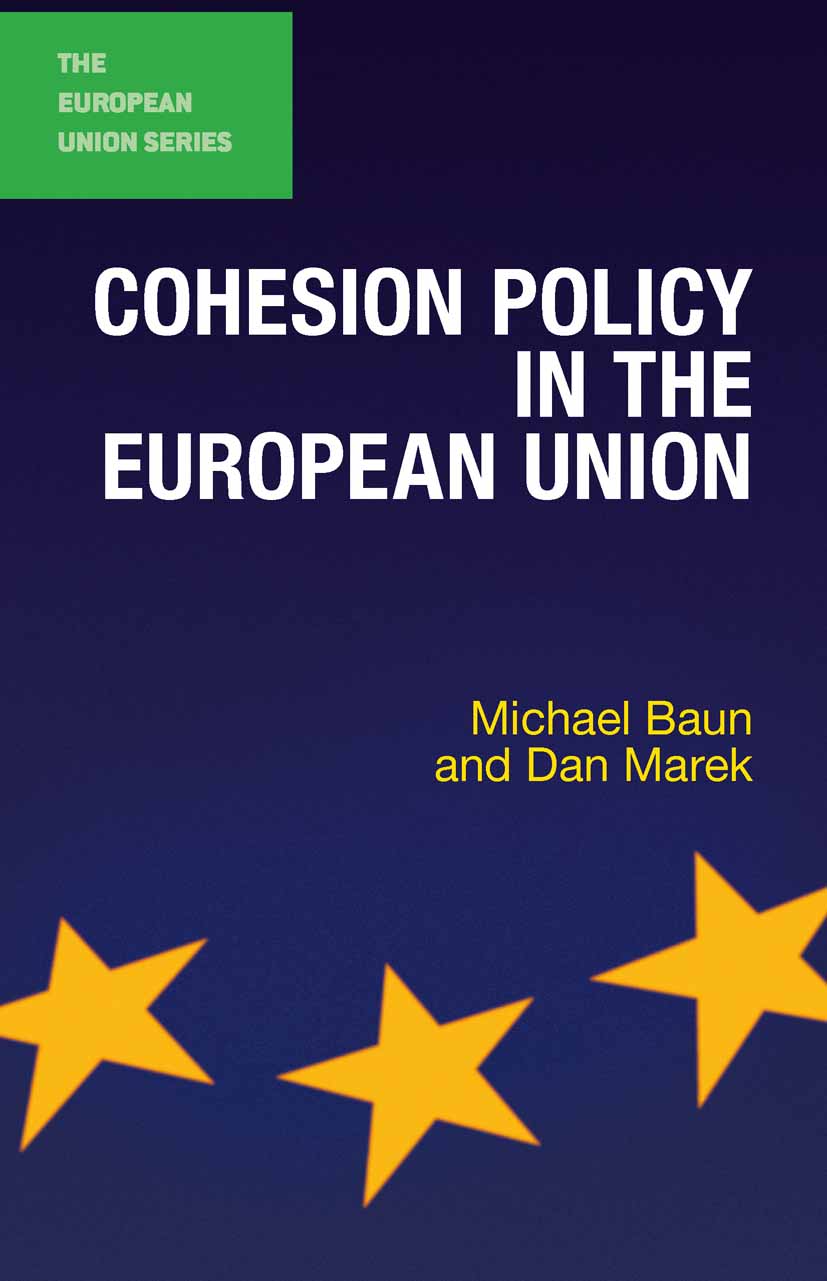
Cohesion Policy in the European Union This textbook by two leading experts looks at the realities and controversies of the European Union's cohesion policy: how effective it is, who it impacts, and what it says about the EU's governance at a wider level. At a time when more EU projects connected with cohesion policy are underway than ever before, and much of Europe is still responding to the effects of the global and eurozone crises, it is important to assess how the policy is benefiting eligible member states, and how it is perceived by European citizens. Taking account of recent developments as well as the changing priorities of the Commission and national governments across time, this comprehensive text is both up-to-date and historically grounded. It considers all aspects of the policy such as the criteria for eligibility; how it is funded; its role in strategies for development, growth and competitiveness; and how it is planned, implemented and evaluated. Furthermore, it examines how contemporary political and economic factors, such as the continuing influence of Germany in Europe and the growing north-side divide, will shape the future of cohesion policy. POLITICAL SCIENCE,World,European
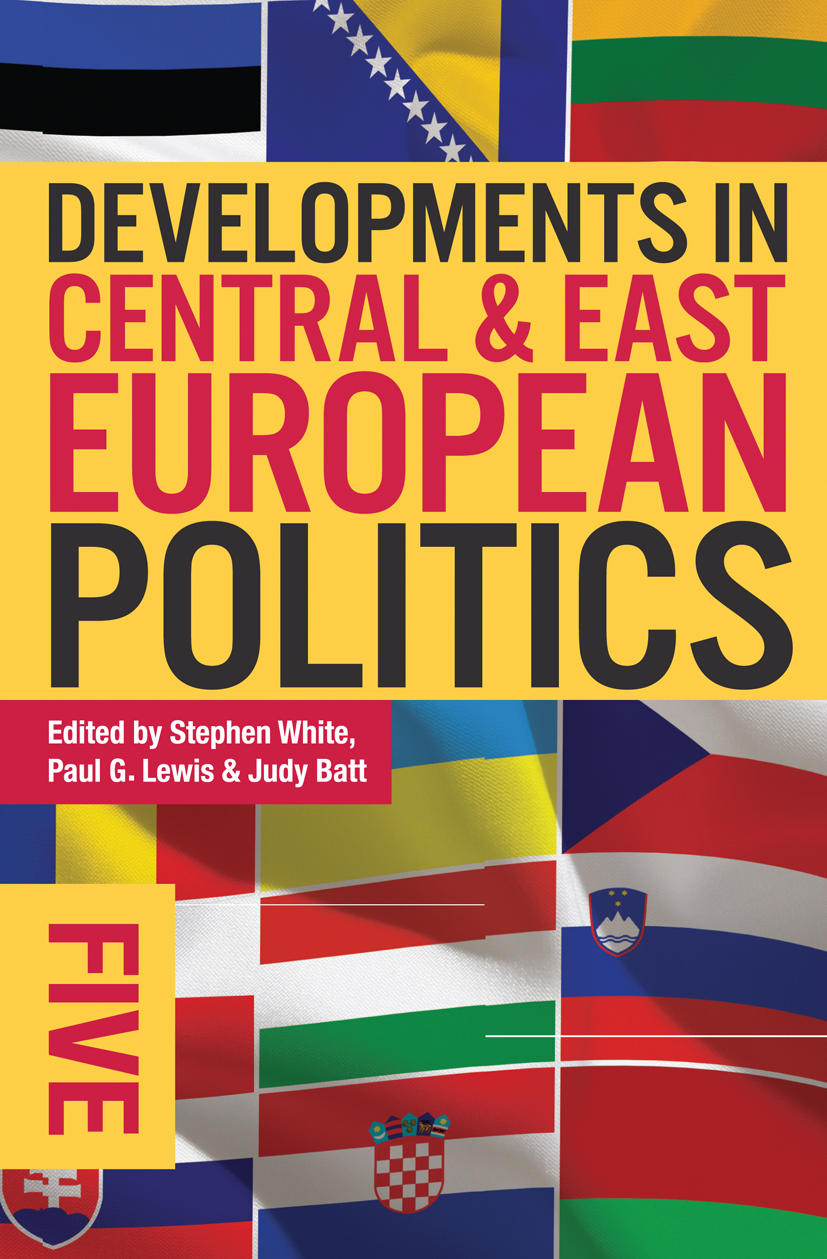
Developments in Central and East European Politics 5 The new edition of this market-leading text brings together specially commissioned chapters by a team of top international scholars on the changing politics of this diverse region negotiating the competing pulls of the European Union and post-communist Russia. POLITICAL SCIENCE,World,European
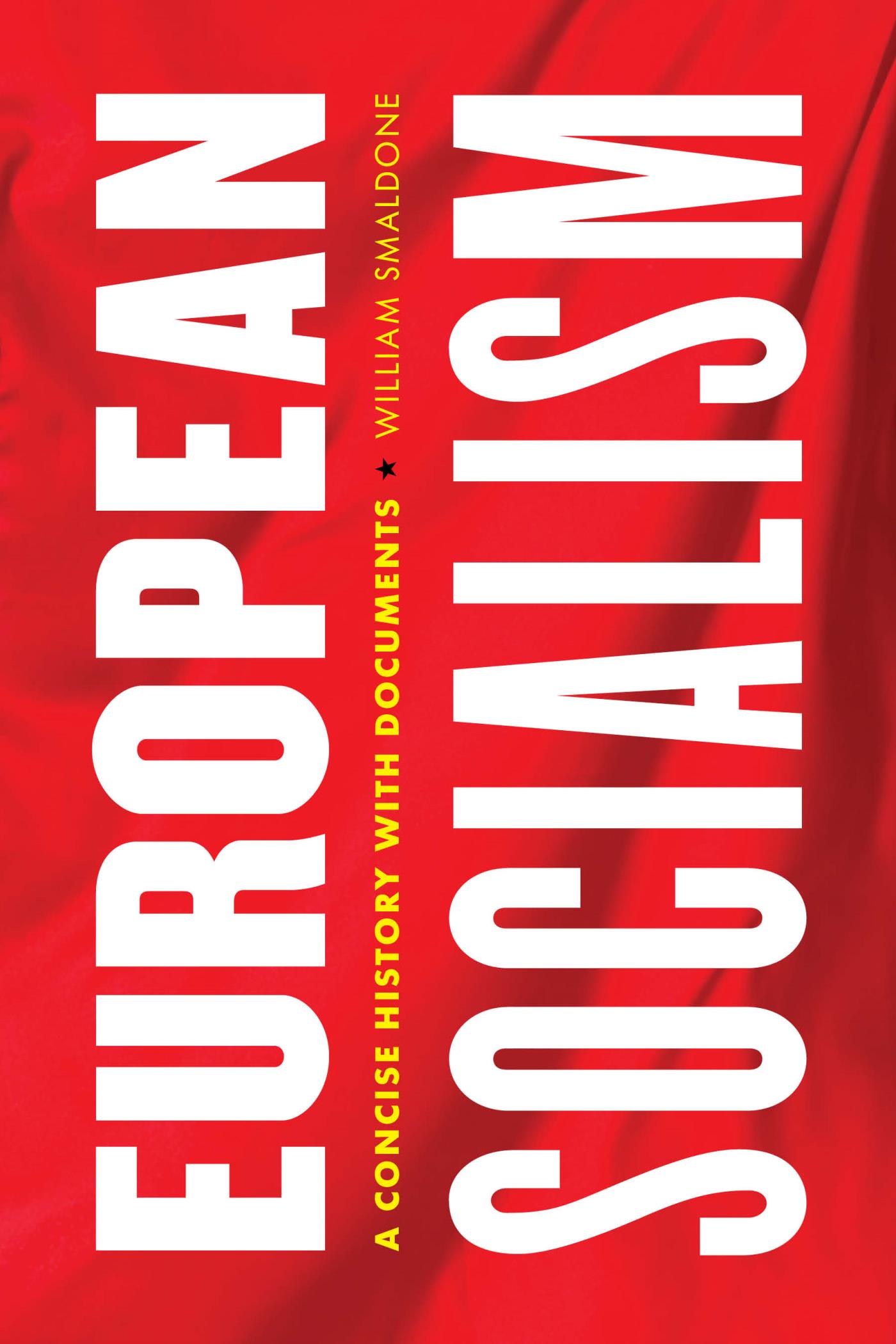
European Socialism This accessible text offers a concise but comprehensive introduction to European socialism, which arose in the maelstrom of the industrial and democratic revolutions launched in the eighteenth century. POLITICAL SCIENCE,World,European
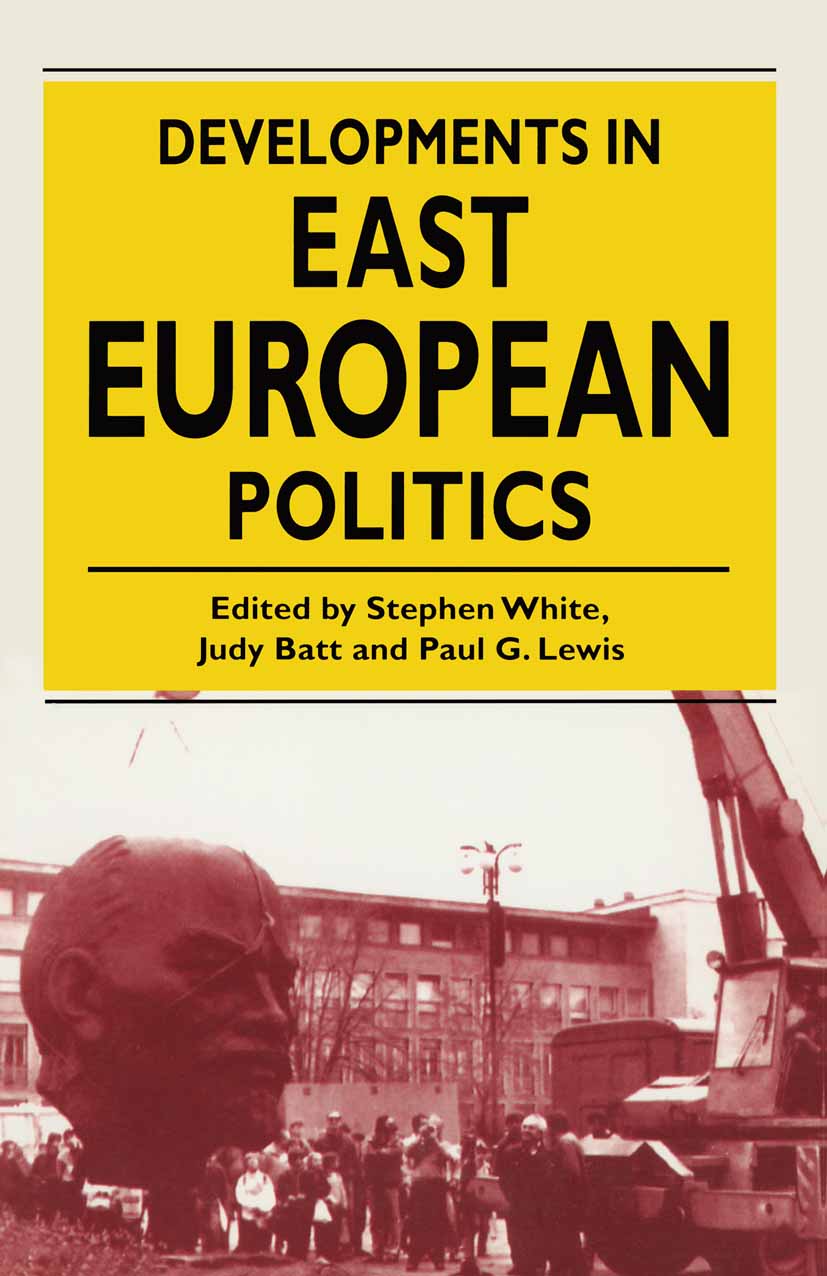
Developments in East European Politics Eastern Europe is changing dramatically. Communist governments have been replaced, economies are being privatised, older nationalisms are reawakening. Developments in Eastern European Politics provides an analytic guide to the politics of transition, including both country studies and more broadly comparative discussions of leaderships and parties, movements and market reforms, social welfare and international politics. Detailed, up to date and authoritative, this will become the first-choice guide to the politics of the new Eastern Europe. POLITICAL SCIENCE,World,European

Britain and the European Union Britain's relationship with the EU has always been riddled with doubt, scepticism and awkwardness. This much-needed new book examines why, how and with what effect the EU has become such a contentious issue in UK politics. It places the debate in historical context by starting with an overview of debates about membership in the 1950s and 1960s and then goes on to examine the impact of Britain's membership since 1973 across core policy areas, including economic and monetary union, agriculture, and foreign and security policy. Andrew Geddes outlines major changes in the scope of the European project and assesses how central, devolved and local governments have responded to the EU. The book also assesses the EU's impact on domestic policies, assessing debates within and between the main parties and charting the rise of Euroscepticism as a key trend in contemporary British politics. Engagingly written, this text provides a comprehensive and up-to-date analysis both of the EU's impact on Britain and of Britain's contribution to the EU. POLITICAL SCIENCE,World,European

Germany and the European Union An up-to-date analysis of Germany's role in the EU. Conceptually it focuses on the impact of domestic interests, institutions and identity on Germany's European diplomacy. Empirically it includes analysis of German policy, the institutions in which it is made, and its origins in elite and public opinion, the political parties and the Länder. POLITICAL SCIENCE,World,European
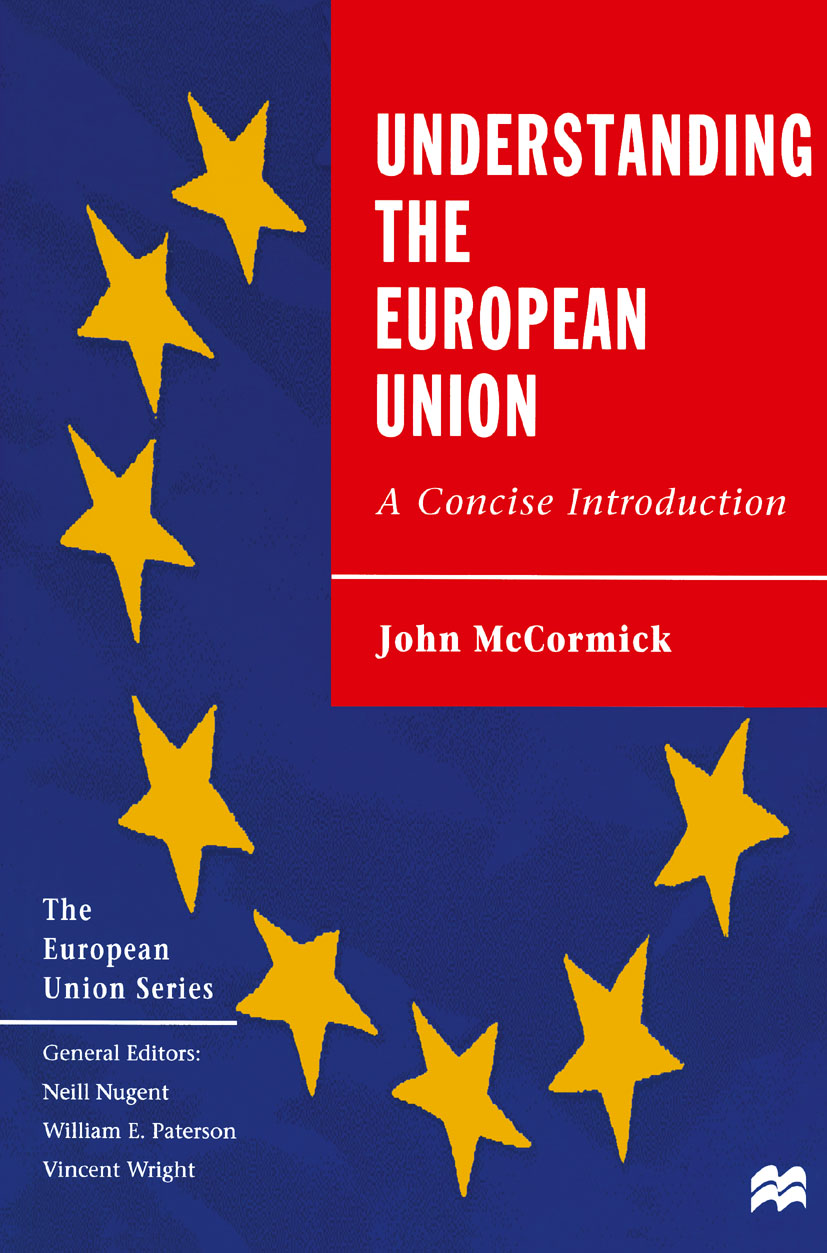
Understanding the European Union Despite the plethora of textbooks available on the European Union and the wide range of interdisciplinary and non-specialist courses on which it is studied, there has, surprisingly, until now been no single text providing concise coverage of all its major dimensions and implications. Rather than focusing just on the history or the politics or the economics of the EU or on detailed coverage of its institutions and/or policies, John McCormick's new book introduces all aspects of European integration combining a very clear and accessible thematic narrative with boxed summaries of a wide range of essential facts and figures. POLITICAL SCIENCE,World,European
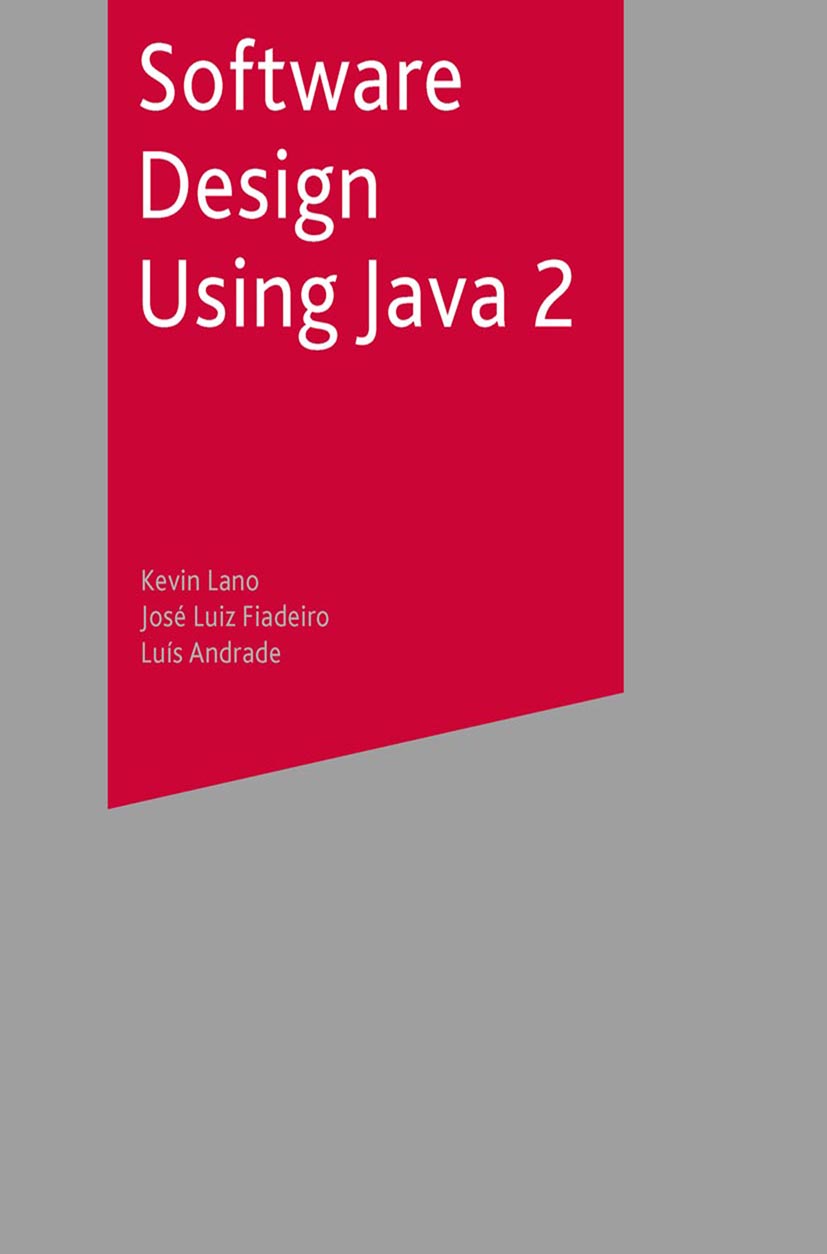
Understanding the European Union An immediate best-seller on first publication, the comprehensively revised, expanded and updated second edition of John McCormick's Understanding the European Union provides a uniquely broad-ranging but concise introduction to the EU. Rather than focusing just on the politics or the economics of the EU or on detailed coverage of its institutions and/or policies, the author covers in one volume all major aspects of European integration combining a very clear and accessible thematic narrative with boxed summaries of a wide range of essential facts and figures. POLITICAL SCIENCE,World,European

The Comrade from Milan In this much-lauded memoir, acclaimed for its blend of literary elegance and political passion, Rossana Rossanda, a legendary figure on the Italian left, reflects on a life of radical commitment. Active as a communist militant in the Italian Resistance against fascism during World War Two, Rossanda rose rapidly in its aftermath, becoming editor of the Communist Party weekly paper and a member of parliament. Initially a party loyalist, she was critical of the party’s conservatism in the face of new radical movements and moved into opposition during the late 1960s. The breach widened after she and others publicly opposed the Soviet invasion of Czechoslovakia, and were expelled in 1969. She went on to help found the influential paper il manifesto, which remains the most critical daily in Berlusconi’s Italy. Her unique experience enables her to reconstruct that period with flair and authority. She paints a revealing picture of fascism, communism, post-war reconstruction and the revolts that shook Europe in the 1960s. In The Comrade from Milan, one of the most influential intellectuals of the European Left relives the storms of the twentieth century. Both cool-headed and precise, Rossanda provides a rare insight into what it once meant to be politically engaged. POLITICAL SCIENCE,World,European

Leviathan The seventeenth-century work of political philosophy that brought us the concept of the social contract. Considered by many to be as influential and provocative as Machiavelli’s The Prince, Thomas Hobbes’s Leviathan, written during the English Civil War, argues that only a people united under a strong sovereign can resist the forces of chaos. Exploring such concepts as the state of nature and the need to escape it, the value of a commonwealth, the advantages of a monarchy, and the role of religion in civil society, Leviathan is a controversial and challenging landmark in the history of political thought. POLITICAL SCIENCE,World,European
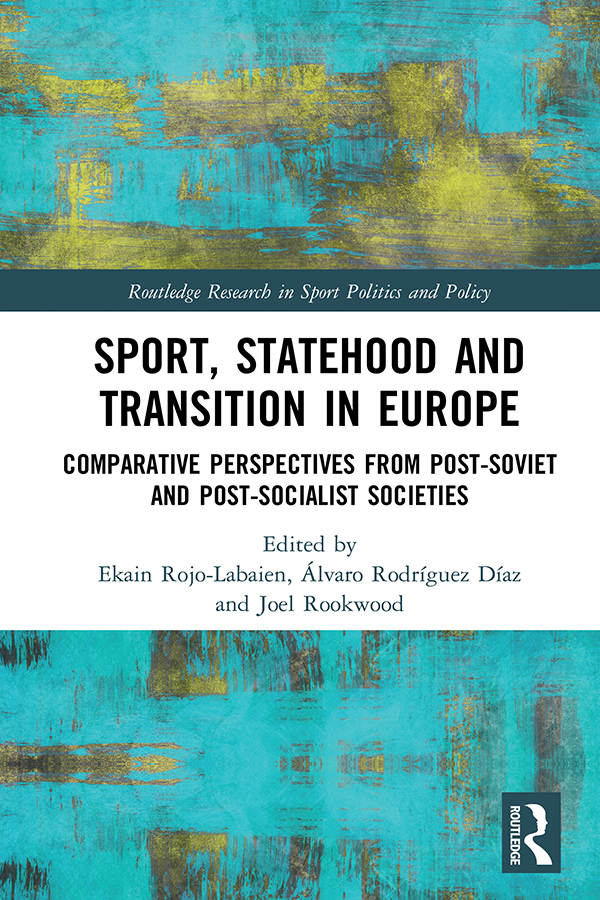
Sport, Statehood and Transition in Europe This book examines the political significance of sport and its importance for nation-state building and political and economic transition across thirteen post-Soviet and post-socialist countries, primarily located in Eastern Europe. Adopting a critical case-study approach, building on historical and comparative frameworks, the book uses sport as a symbolic lens through which to examine the transition of Eastern European countries to the Western capitalist system. Covering a wide geographical area, from Poland to the Caucuses and Turkmenistan, it explores key themes such as nationalism, governance, power relations, political ideology, separatism, commercialisation and economic development, and the symbolic value of mega-events. Sport, Statehood and Transition in Europe is fascinating reading for anybody with an interest in sport policy, the politics of sport or political science. POLITICAL SCIENCE,World,European

Adoption of EU Business and Human Rights Policy This book explores how and why the transposition of EU directives in the new and contentious policy area ‘Business and Human Rights’ differs between member states. It reveals the extent to which individual member states are pursuing diverging approaches in dealing with the ‘discretionary space’ in EU directives, and highlights theoretical and political explanations. Drawing on historical institutionalism and rational choice institutionalism, the book establishes a link between the degree of corporatism in a given political economy and government behaviour in terms of Business and Human Rights policy. Moreover, it identifies political salience within the policy subsystem as a pertinent factor for explaining national transposition outcomes. POLITICAL SCIENCE,World,European

European Union Politics European Union Politics provides an authoritative introduction to all aspects of politics and policy in the EU. It gives readers a sense of the colour and flavour of EU politics, while systematic coverage of different theoretical perspectives encourages a more sophisticated understanding of how and why the EU has become what it is today. POLITICAL SCIENCE,World,European
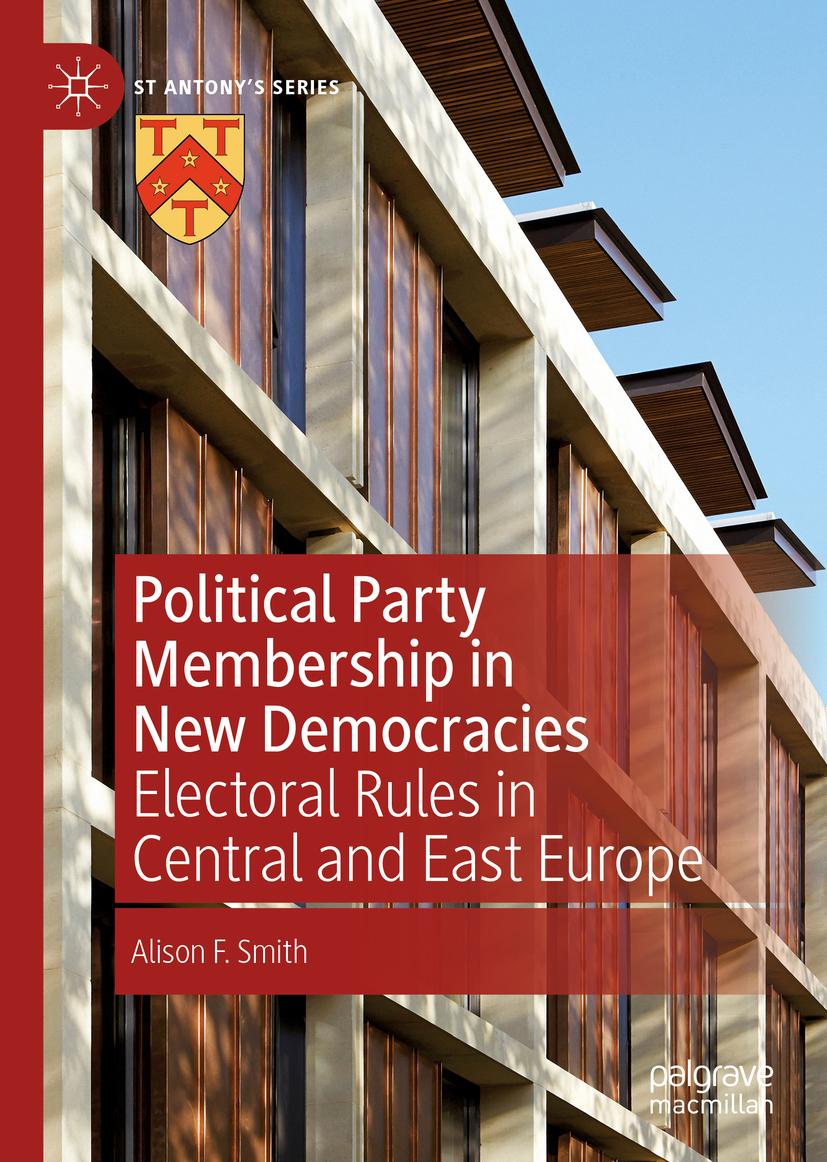
Political Party Membership in New Democracies This book explores the impact of electoral rules on political party development in Central and East Europe. It finds that ‘high district magnitude’ proportional electoral systems encourage centralised organisational development and campaigning – where communication with voters is conducted primarily via mass, social and digital media – while small electoral districts stimulate grassroots campaigning. As a result, low magnitude electoral systems are more likely to create an active role for party members, stimulating membership recruitment. The book further examines how parties organise and campaign on the ground. The analysis of in-depth surveys and interviews with party elites in Estonia, Lithuania and Slovakia sheds light on areas of party life that are rarely examined, including party fundraising. Overall, the effects of electoral systems on party organisation and campaigning reflect patterns previously observed in Western Europe, demonstrating that a degree of convergence has occurred. POLITICAL SCIENCE,World,European
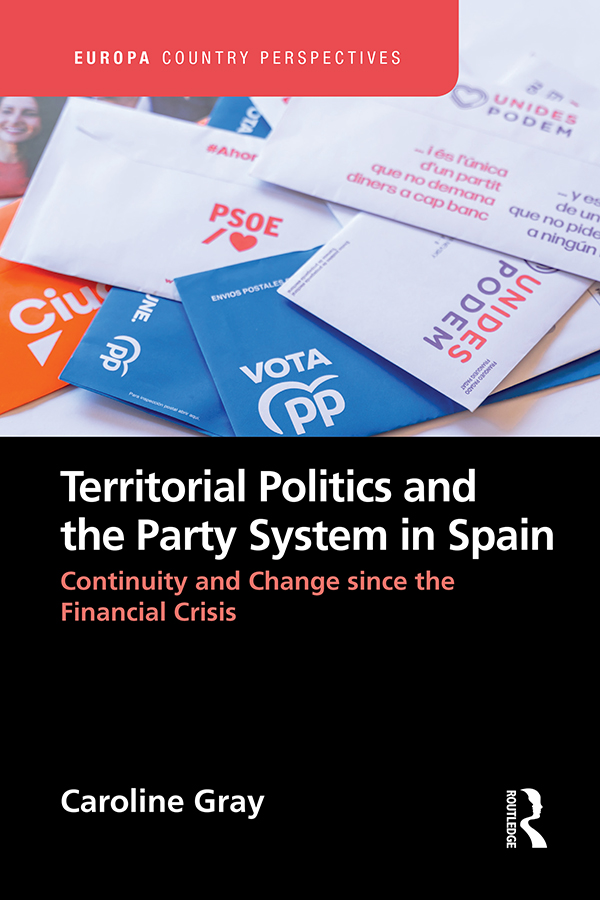
Territorial Politics and the Party System in Spain Across Western Europe, the global financial crisis of 2008 and its aftermath not only brought economic havoc but also, in turn, intense political upheaval. Many of the political manifestations of the crisis seen in other Western and especially Southern European countries also hit Spain, where challenger parties caused unprecedented parliamentary fragmentation, resulting in four general elections in under four years from 2015 onwards. Yet Spain, a decentralised state where extensive powers are devolved to 17 regions known as ‘autonomous communities’, also stood out from its neighbours due to the importance of the territorial dimension of politics in shaping the political expression of the crisis. This book explains how and why the territorial dimension of politics contributed to shaping party system continuity and change in Spain in the aftermath of the financial crisis, with a particular focus on party behaviour. The territorial dimension encompasses the demands for ever greater autonomy or even sovereignty coming from certain parties within the historic regions of the Basque Country, Catalonia and, to a lesser extent, Galicia. It also encompasses where these historic regions sit within the broader dynamics of intergovernmental relations across Spain’s 17 autonomous communities in total, and how these dynamics contribute to shaping party strategies and behaviour in Spain. Such features became particularly salient in the aftermath of the financial crisis since this coincided with, and indeed accelerated, the rise of the independence movement in Catalonia. POLITICAL SCIENCE,World,European
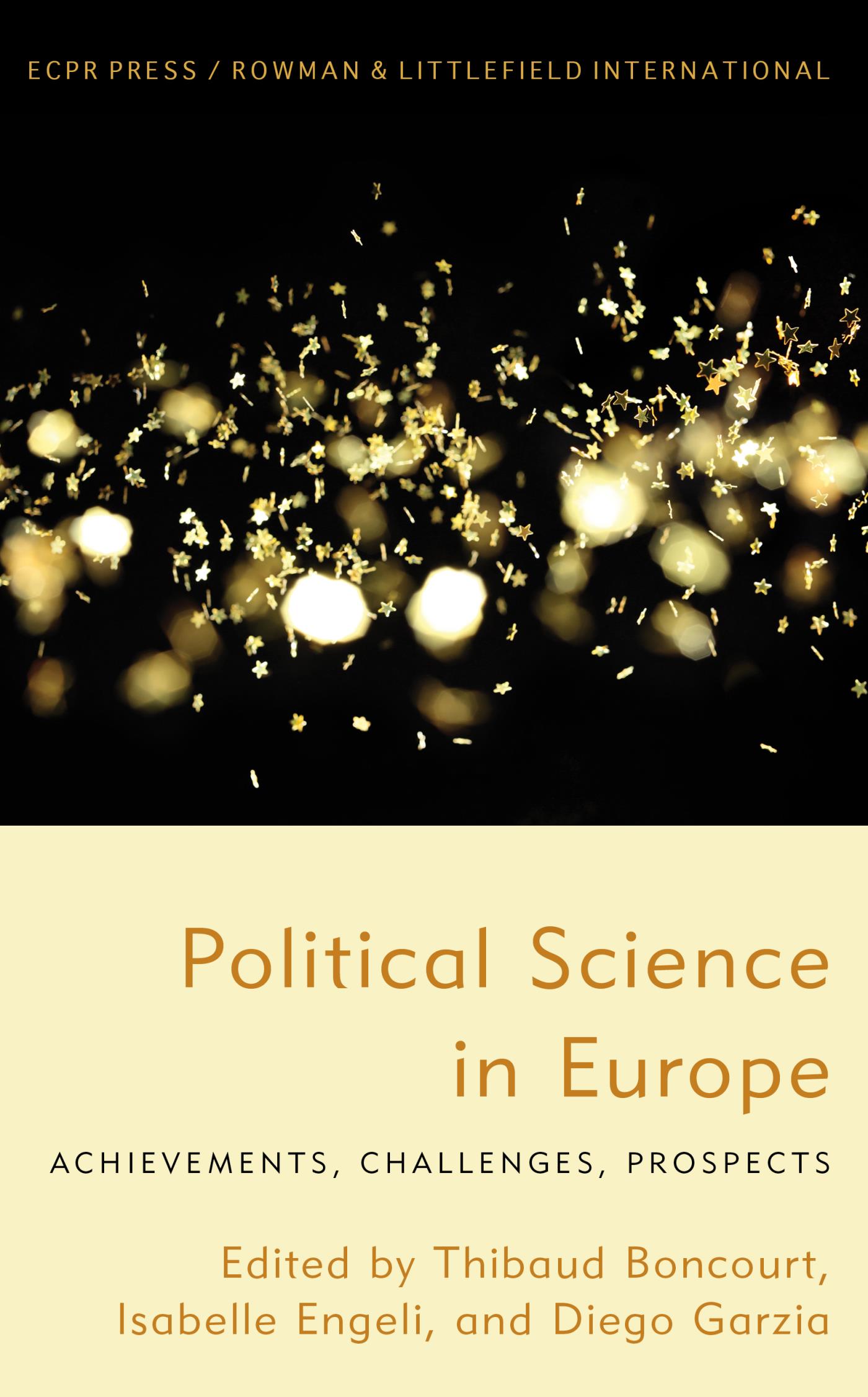
Political Science in Europe This collection reflects on the origins and development of European political science and provide a critical assessment of the achievements and challenges lying ahead. POLITICAL SCIENCE,World,European
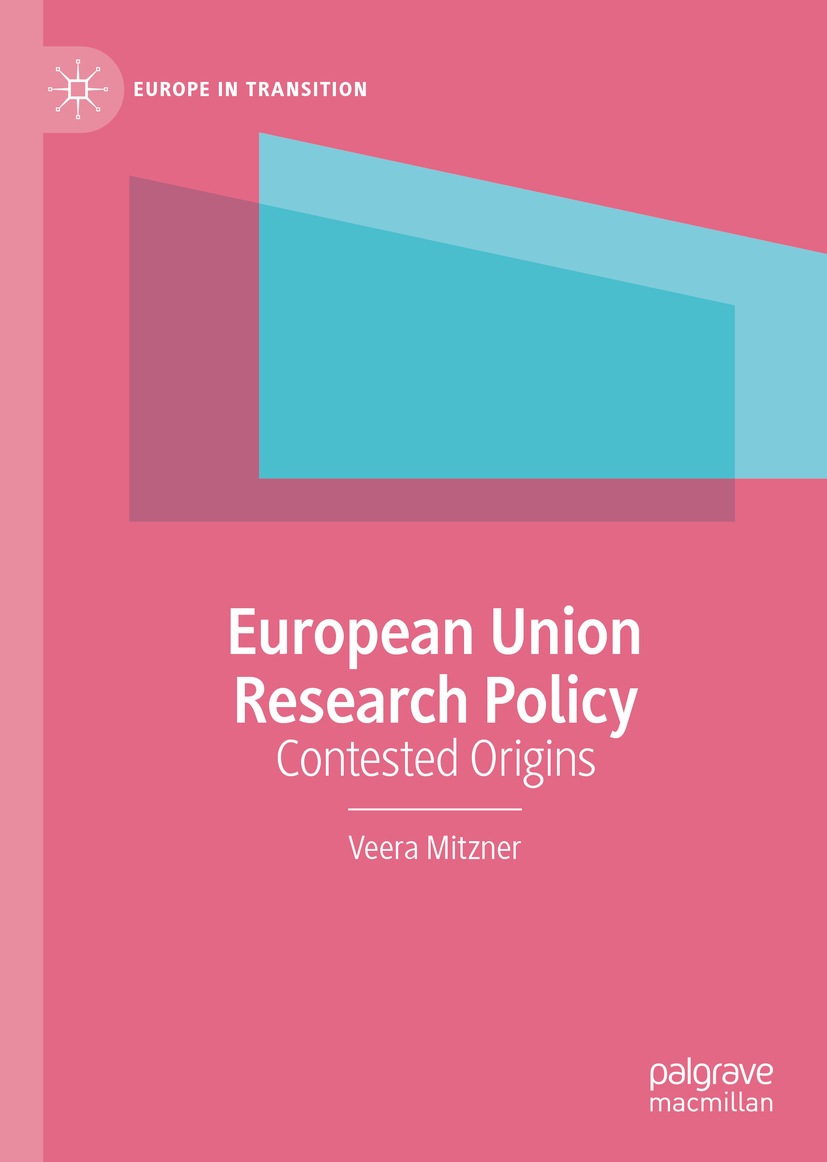
European Union Research Policy This book describes the emergence of research policy as a key competence of the European Union (EU). It shows how the European Community (EC, the predecessor of the EU), which initially had very limited legal competence in the field, progressively developed a solid policy framework presenting science and research as indispensable tools for European economic competitiveness and growth. In the late 20th century Western Europe, hungry for growth, concerned about the American technological lead, and keen to compete in the increasingly open international markets, the argument for a joint European effort in science and technology seemed plausible. However, the EC was building its new functions in an already crowded field of European research collaboration and in a shifting political context marked by austerity, national rivalries, new societal and environmental challenges, and emerging ambivalence about science. This book conveys the contested history of one of the EU’s most successful policies. It is a story of struggle and frustration but also of a great institutional and intellectual continuity. The ideational edifice for the EC/EU research policy that was put in place during the 1960s and 1970s years proved remarkably robust. Its durability enabled the rapid takeoff of the European Commission’s initiatives in the more favorable political atmosphere of the early 1980s and the subsequent expansion of the EU research funding instruments and programs that permanently transformed the European research landscape. POLITICAL SCIENCE,World,European
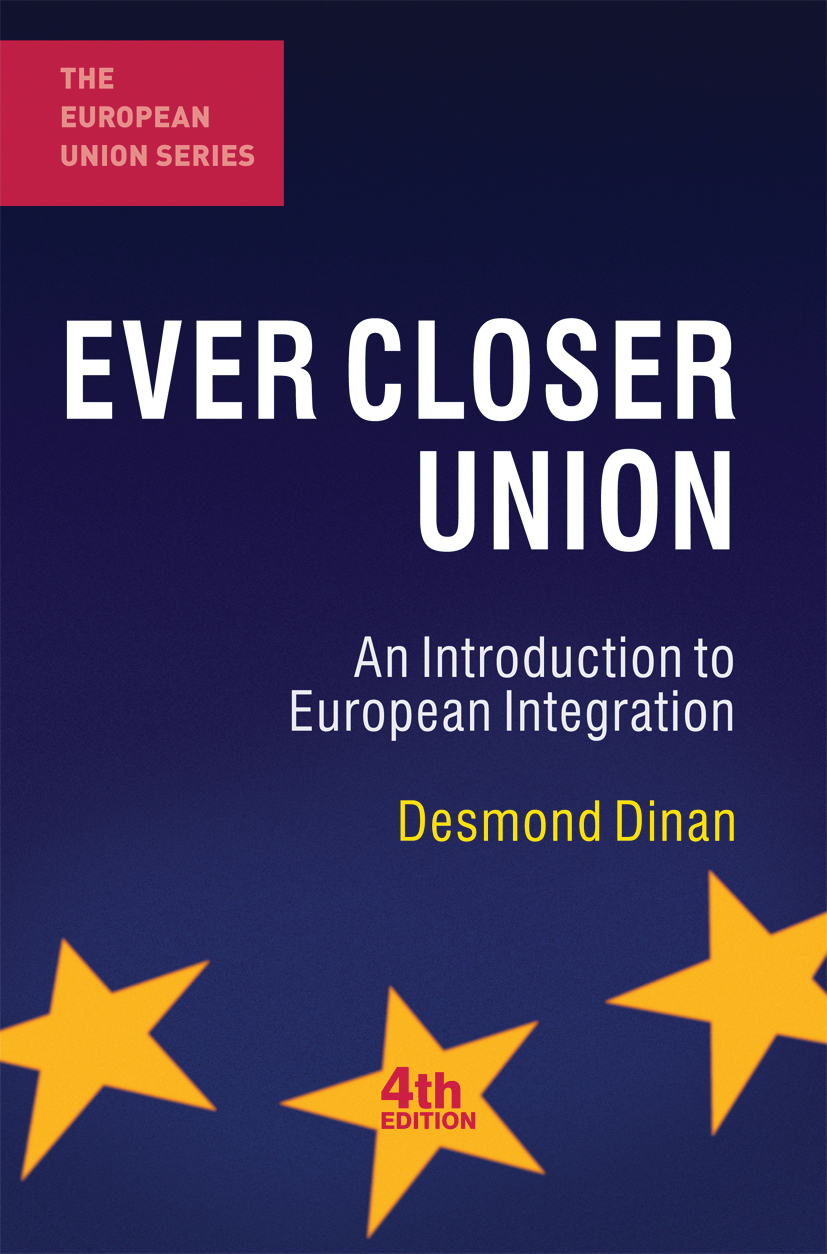
Ever Closer Union Ever Closer Union clearly and engagingly introduces the complexities of European integration. The 4th edition is fully revised and updated to take account of major changes in the EU, including full coverage of the impact of the Lisbon Treaty. POLITICAL SCIENCE,World,European

The European Parliament Election of 2019 in East-Central Europe This book provides an analysis of the European Parliament elections 2019 with a focus on East-Central European countries. The authors offer conceptual insights into Euroscepticism and discuss traditionally familiar concepts in a new light, pairing East-Central European Euroscepticism with visions of illiberal democracy, on the one hand, and showing the increasing Europeanisation of Eurosceptic parties in the region, on the other. The book combines a fresh and innovative conceptual treatment with rich and accurate empirical evidence in order to highlight the dynamics of Euroscepticism in "new" EU member states. Students and experts interested in EU politics, within academia and beyond, will find this volume particularly informative. POLITICAL SCIENCE,World,European

Recruiting and Retaining Party Activists This book explores how experienced party organisers in the UK work to recruit and to retain party activists for local campaigning. Local door-to-door campaigning is widely regarded as being a key element in a successful election campaign. However, for door-to-door campaigning to work, a large number of volunteer activists are required. The question then is: How can parties identify, recruit and retain such volunteer activists? Based on interviews with highly experienced campaigners, original party documents, the wider campaigning and volunteering literature, numerous informal conversations and the author’s own experience of local campaigning over a 20 year period, this book provides an answer to that question. It shows how potential activists are identified, encouraged to become active and supported through their initial encounter with local campaigning. The author also shows how local parties can encourage activists to remain active by creating a ‘retention enhancing campaigning environment’ and what that involves. POLITICAL SCIENCE,World,European
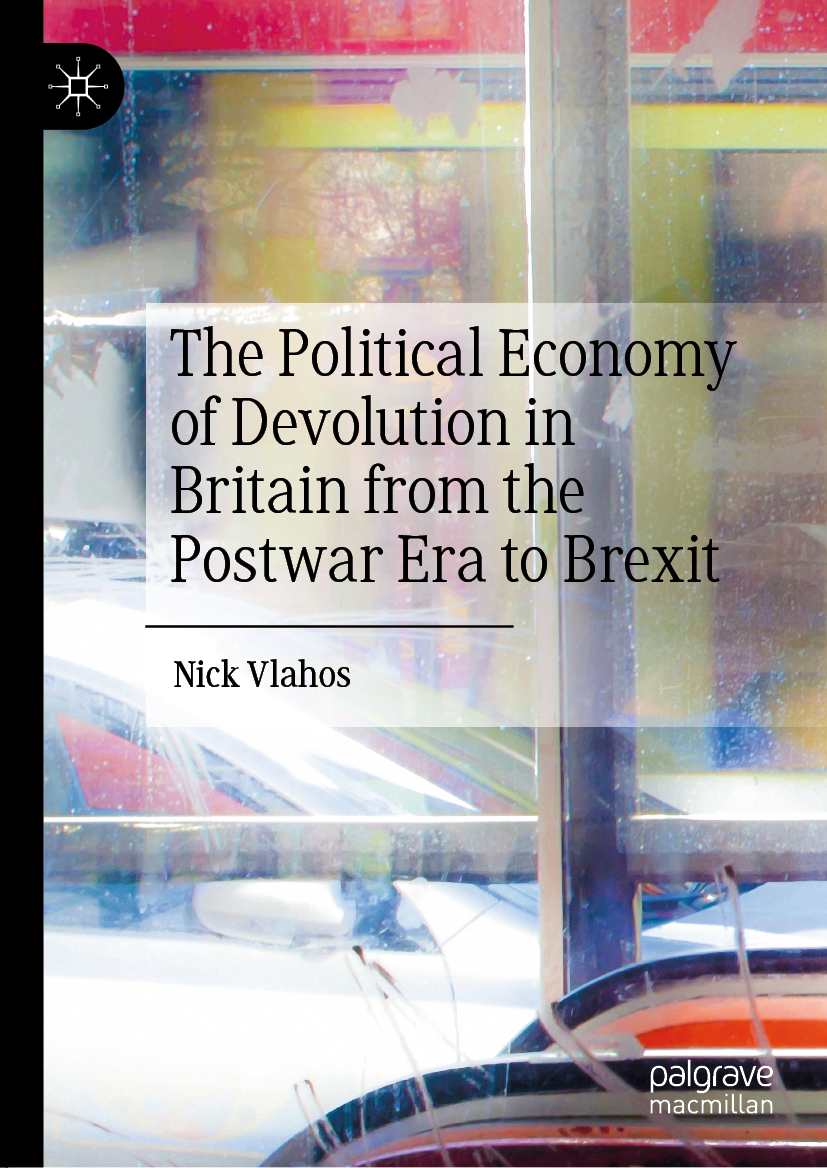
The Political Economy of Devolution in Britain from the Postwar Era to Brexit This book examines the political economy of devolution in Britain from the postwar period to the present. It situates devolution in Britain within an understanding of the partisan recalibration of political, economic and democratic scales (or levels) of the state. The author utilizes various explanatory tools to unpack complex social, economic, spatial and political phenomena across national, regional and local scales. The book further contributes to our conceptual understanding of decentralization as a broader, comparative, phenomenon. Particular emphasis is placed on examining why decentralization and devolution occur at particular points in time, which enables the investigation into how political and fiscal powers are (re)organized at different levels of the state. POLITICAL SCIENCE,World,European

Fractured Continent A Financial Times Best Political Book of 2017 An urgent examination of how the political and social volatility in Europe impacts the United States and the rest of the world. The dream of a United States of Europe is unraveling in the wake of several crises now afflicting the continent. The single Euro currency threatens to break apart amid bitter arguments between rich northern creditors and poor southern debtors. Russia is back as an aggressive power, annexing Crimea, supporting rebels in eastern Ukraine, and waging media and cyber warfare against the West. Marine Le Pen’s National Front won a record 34 percent of the French presidential vote despite the election of Emmanuel Macron. Europe struggles to cope with nearly two million refugees who fled conflicts in the Middle East and North Africa. Britain has voted to leave the European Union after forty-three years, the first time a member state has opted to quit the world’s leading commercial bloc. At the same time, President Trump has vowed to pursue America First policies that may curtail U.S. security guarantees and provoke trade conflicts with its allies abroad. These developments and a growing backlash against globalization have contributed to a loss of faith in mainstream ruling parties throughout the West. Voters in the United States and Europe are abandoning traditional ways of governing in favor of authoritarian, populist, and nationalist alternatives, raising a profound threat to the future of our democracies. In Fractured Continent, William Drozdiak, the former foreign editor of The Washington Post, persuasively argues that these events have dramatic consequences for Americans as well as Europeans, changing the nature of our relationships with longtime allies and even threatening global security. By speaking with world leaders from Brussels to Berlin, Rome to Riga, Drozdiak describes the crises. the proposed solutions, and considers where Europe and America go from here. The result is a timely character- and narrative-driven book about this tumultuous phase of contemporary European history. POLITICAL SCIENCE,World,European

Changing Perceptions of the EU at Times of Brexit This volume brings together contributions that conceptualize and measure EU perceptions in the strategic regions around the world in the aftermath of the UK referendum. Contributors assess the evolution of EU perceptions in each location and discuss how their findings may contribute to crafting foreign policy options for the "new EU-27". Brexit is very likely to have a substantial bearing on EU external policy, not merely because of the loss of a major member state with a special relationship to the US and the Commonwealth, but also because it challenges the integrational success story that the EU strives to embody. This book thus serves a dual purpose: on the one hand it broadens the recent studies on Brexit by focusing on external partners’ reactions, and on the other it allows for an innovative evaluation of policy options for EU foreign policy. Based on a solid theoretical foundation and empirically rich data, it constitutes an innovative and timely addition to the evolving debate on Brexit and its consequences. This book will be of key interest to scholars and students of European politics, Brexit, British politics, EU politics, comparative politics and international relations. POLITICAL SCIENCE,World,European
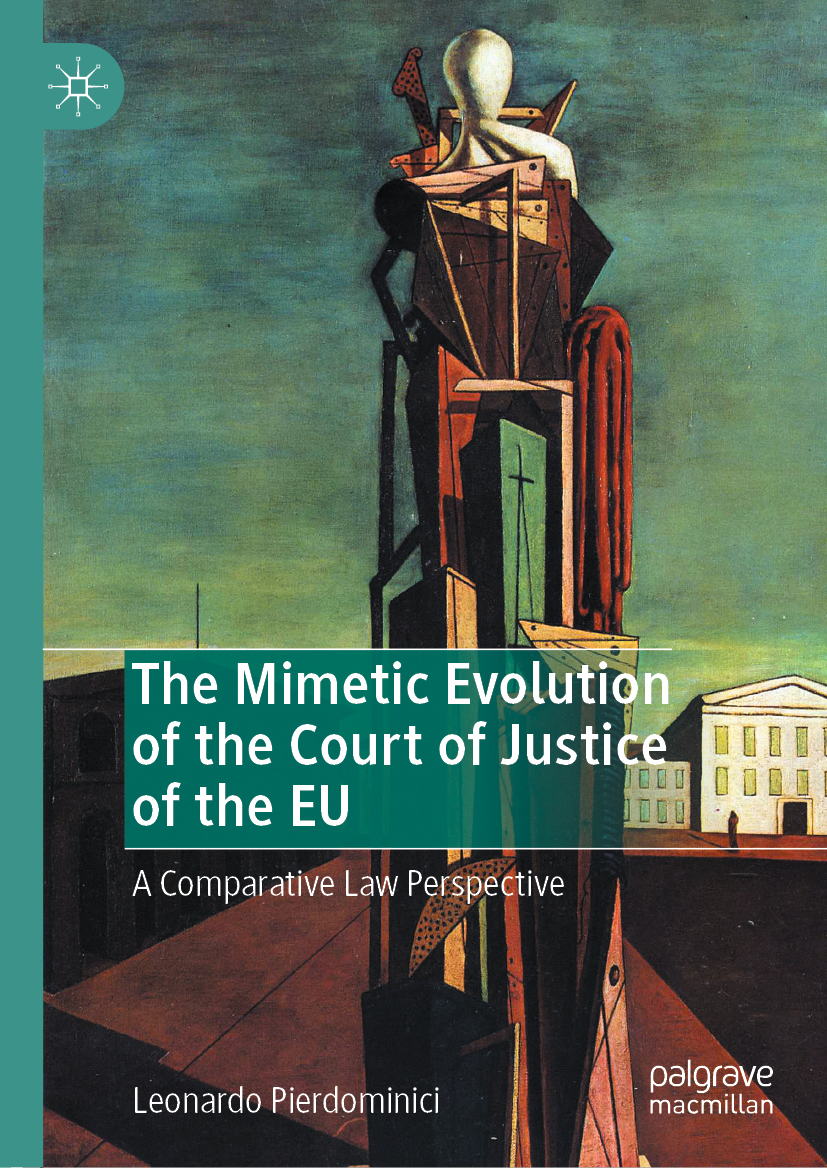
The Mimetic Evolution of the Court of Justice of the EU This book provides fresh perspectives in the legal study of the Court of Justice of the European Union. In the context of European studies, the Court has mainly been analysed in light of its central role in the process of continental integration. Moreover, the Court has traditionally been studied by specialists for its important role as an agent of comparative law. This book studies the evolution of the Court itself, rather than that of the EU legal order in its judge-made dimension, and addresses several institutional aspects of its structure and organization, selected and constructed as a complete range of symptomatic figures of judicial institutionalisation. In doing so, the author seeks to showcase how the development and the institutional evolution of the CJEU happened through a selective internalization of comparative influences. POLITICAL SCIENCE,World,European

The Securitisation of News in Turkey This book examines why Turkey has become infamous as a repressor of news media freedom. For the past decade or so it has stood alongside China as a notorious jailer of journalists – at the same time as being a candidate state of the EU. The author argues that the reasons for this conundrum are complex and whilst the AKP is responsible for the most recent illiberality, its actions should be taken in the wider context of Turkish politics – and the three way battle for power which has been raging between Kemalists, Kurds and Islamists since the republic was founded in 1923. The AKP are the current winners of this tripartite power struggle and the securitisation of journalists as terrorists is part of that quest. Moreover, whilst securitisation is not new, it has intensified recently as the number of the AKP’s political opponents has proliferated. Securitisation is also a means of delegitimising journalism – and neutralizing any threat to the AKP’s electoral prospects – whilst maintaining a democratic façade on the world stage. Lastly, the book argues that whilst the AKP’s securitisation of news began as a means of quashing the reporting of illiberality against wider political targets, since 2016 it has become a target in its own right. In the battle for power in Turkey, journalism is now one of the many losers. POLITICAL SCIENCE,World,European
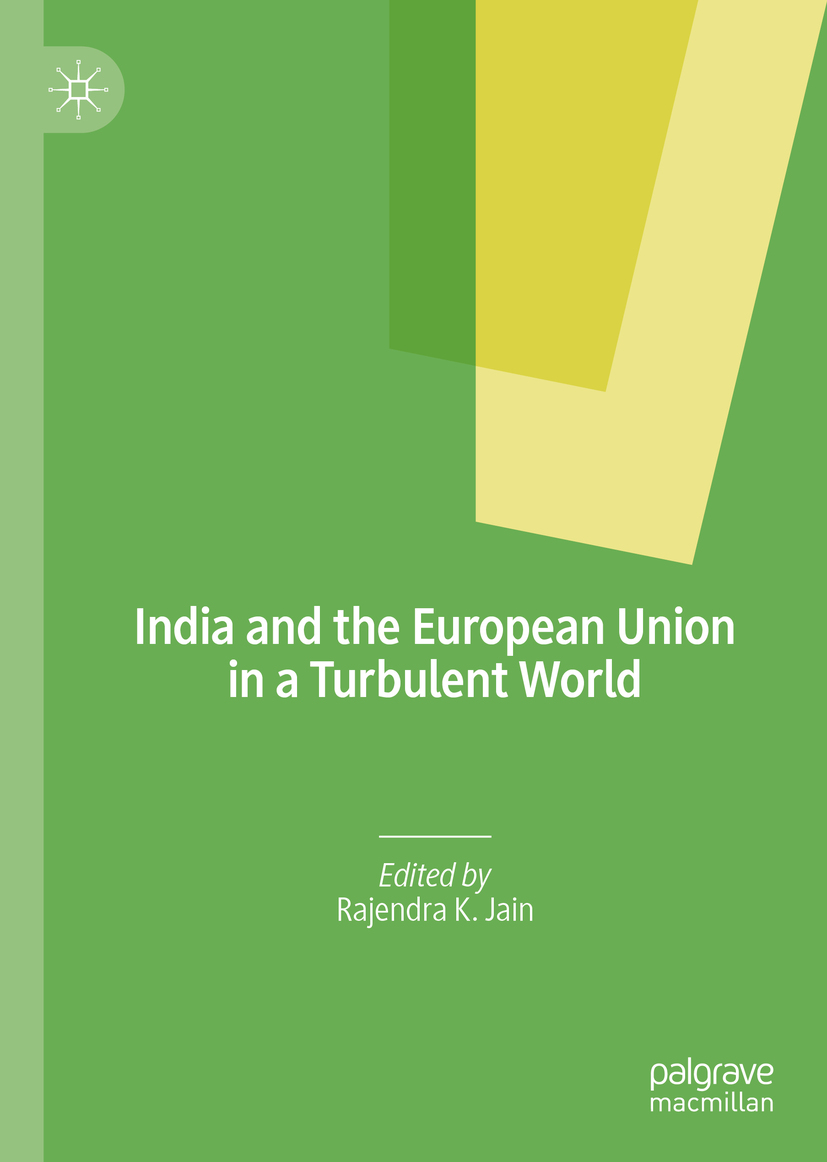
India and the European Union in a Turbulent World The book examines how the European Union, which in the past had tended to be seen by India as an undervalued partner, is now increasingly part of most conversations in fields like the economy, technology, standards, best practices, development, defence and security. The book shows that the renewed focus on Europe is the result of changing geopolitics, India’s own priorities, Europe’s growing relevance in the post-Brexit era, China’s expanding footprint in the continent, and the search for alternatives to the loss of the UK as the gateway to Europe. The uncertainty inherent in the Brexit process and with the UK ceasing/having ceased to be the traditional gateway to Europe, India has been compelled to revisit, re-examine and rethink its own policies towards Europe and search for alternatives to Britain. POLITICAL SCIENCE,World,European
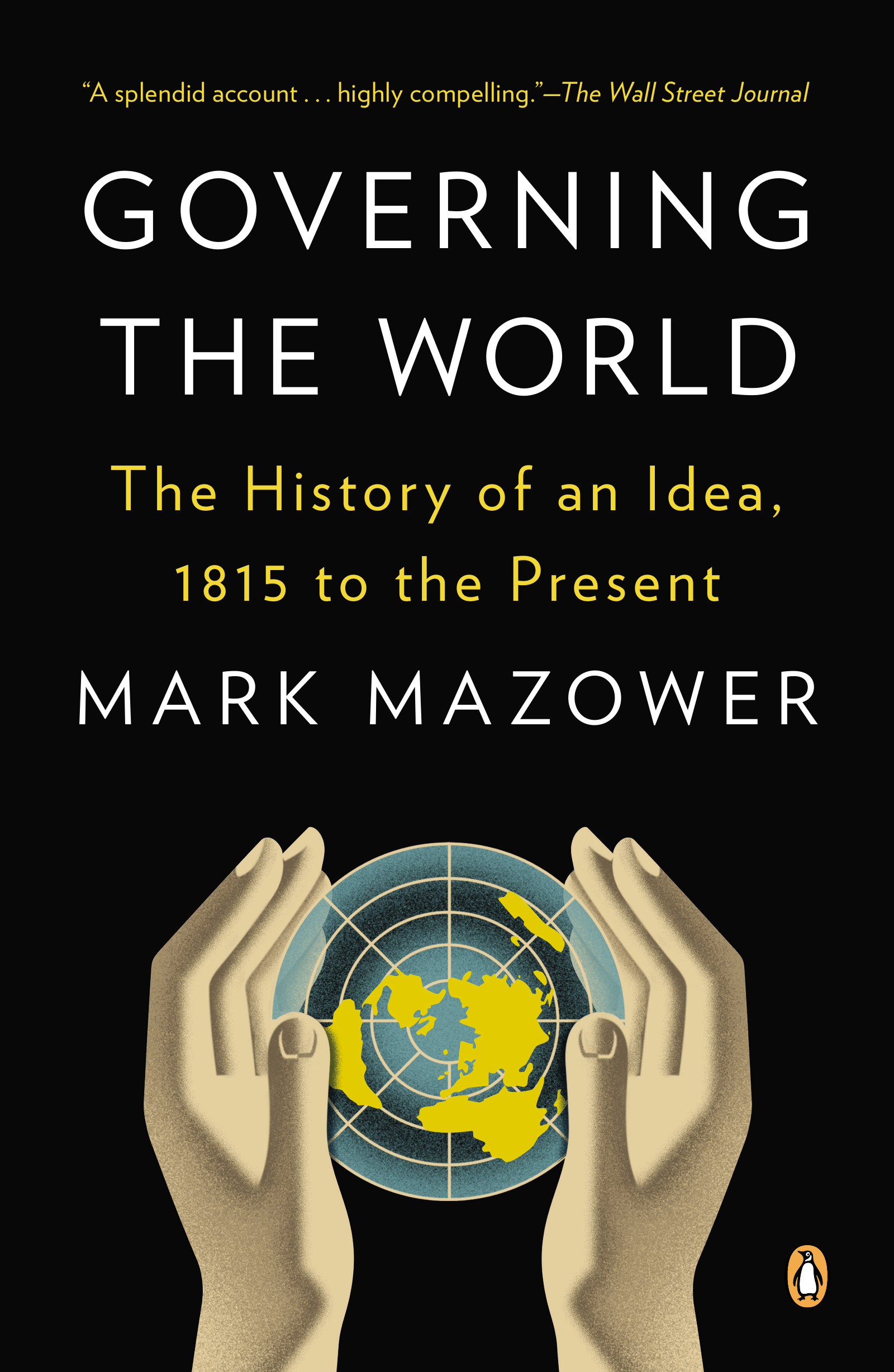
Governing the World The story of global cooperation between nations and peoples is a tale of dreamers goading us to find common cause in remedying humanity’s worst problems. But international institutions have also provided a tool for the powers that be to advance their own interests and stamp their imprint on the world. Mark Mazower’s Governing the World tells the epic story of that inevitable and irresolvable tension—the unstable and often surprising alchemy between ideas and power. From the beginning, the willingness of national leaders to cooperate has been spurred by crisis: the book opens in 1815, amid the rubble of the Napoleonic Empire, as the Concert of Europe was assembled with an avowed mission to prevent any single power from dominating the continent and to stamp out revolutionary agitation before it could lead to war. But if the Concert was a response to Napoleon, internationalism was a response to the Concert, and as courts and monarchs disintegrated they were replaced by revolutionaries and bureaucrats. 19th century internationalists included bomb-throwing anarchists and the secret policemen who fought them, Marxist revolutionaries and respectable free marketeers. But they all embraced nationalism, the age’s most powerful transformative political creed, and assumed that nationalism and internationalism would go hand in hand. The wars of the twentieth century saw the birth of institutions that enshrined many of those ideals in durable structures of authority, most notably the League of Nations in World War I and the United Nations after World War II. Throughout this history, we see that international institutions are only as strong as the great powers of the moment allow them to be. The League was intended to prop up the British empire. With Washington taking over world leadership from Whitehall, the United Nations became a useful extension of American power. But as Mazower shows us, from the late 1960s on, America lost control over the dialogue and the rise of the independent Third World saw a marked shift away from the United Nations and toward more pliable tools such as the World Bank and the International Monetary Fund. From the 1990s to 2007, Governing the World centers on a new regime of global coordination built upon economic rule-making by central bankers and finance ministers, a regime in which the interests of citizens and workers are trumped by the iron logic of markets. Now, the era of Western dominance of international life is fast coming to an end and a new multi-centered global balance of forces is emerging. We are living in a time of extreme confusion about the purpose and durability of our international institutions. History is not prophecy, but Mark Mazower shows us why the current dialectic between ideals and power politics in the international arena is just another stage in an epic two-hundred-year story. POLITICAL SCIENCE,World,General
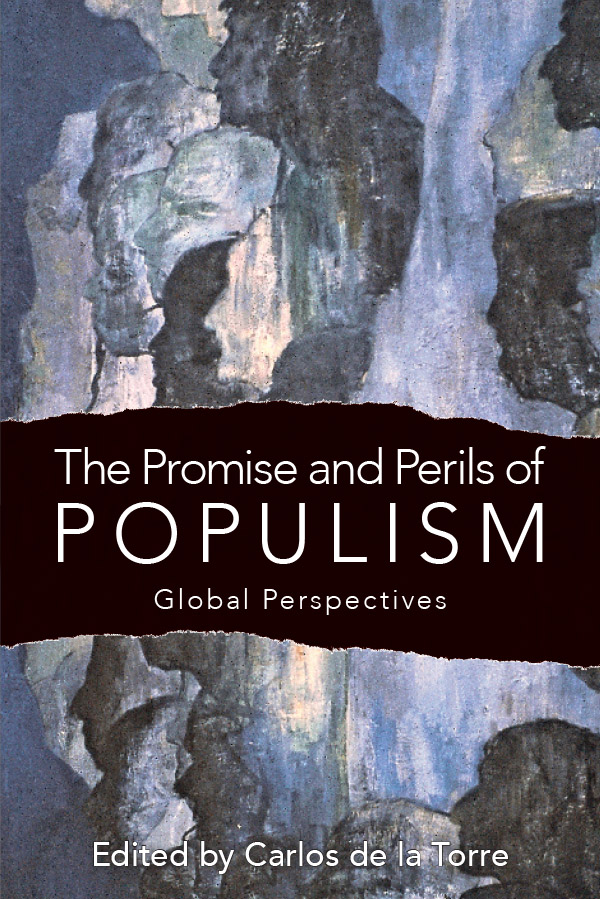
The Promise and Perils of Populism From the protesters in Cairo's Tahrir Square to the Tea Party in the United States to the campaign to elect indigenous leader Evo Morales in Bolivia, modern populist movements command international attention and compel political and social change. When citizens demand "power to the people," they evoke corrupt politicians, imperialists, or oligarchies that have appropriated power from its legitimate owners. These stereotypical narratives belie the vague and often contradictory definitions of the concept of "the people" and the many motives of those who use populism as a political tool. In The Promise and Perils of Populism, Carlos de la Torre assembles a group of international scholars to explore the ambiguous meanings and profound implications of grassroots movements across the globe. These trenchant essays explore how fragile political institutions allow populists to achieve power, while strong institutions confine them to the margins of political systems. Their comparative case studies illuminate how Latin American, African, and Thai populists have sought to empower marginalized groups of people, while similar groups in Australia, Europe, and the United States often exclude people whom they consider to possess different cultural values. While analyzing insurrections in Latin America, advocacy groups in the United States, Europe, and Australia, and populist parties in Asia and Africa, the contributors also pose questions and agendas for further research. This volume on contemporary populism from a comparative perspective could not be more timely, and scholars from a variety of disciplines will find it an invaluable contribution to the literature. POLITICAL SCIENCE,World,General
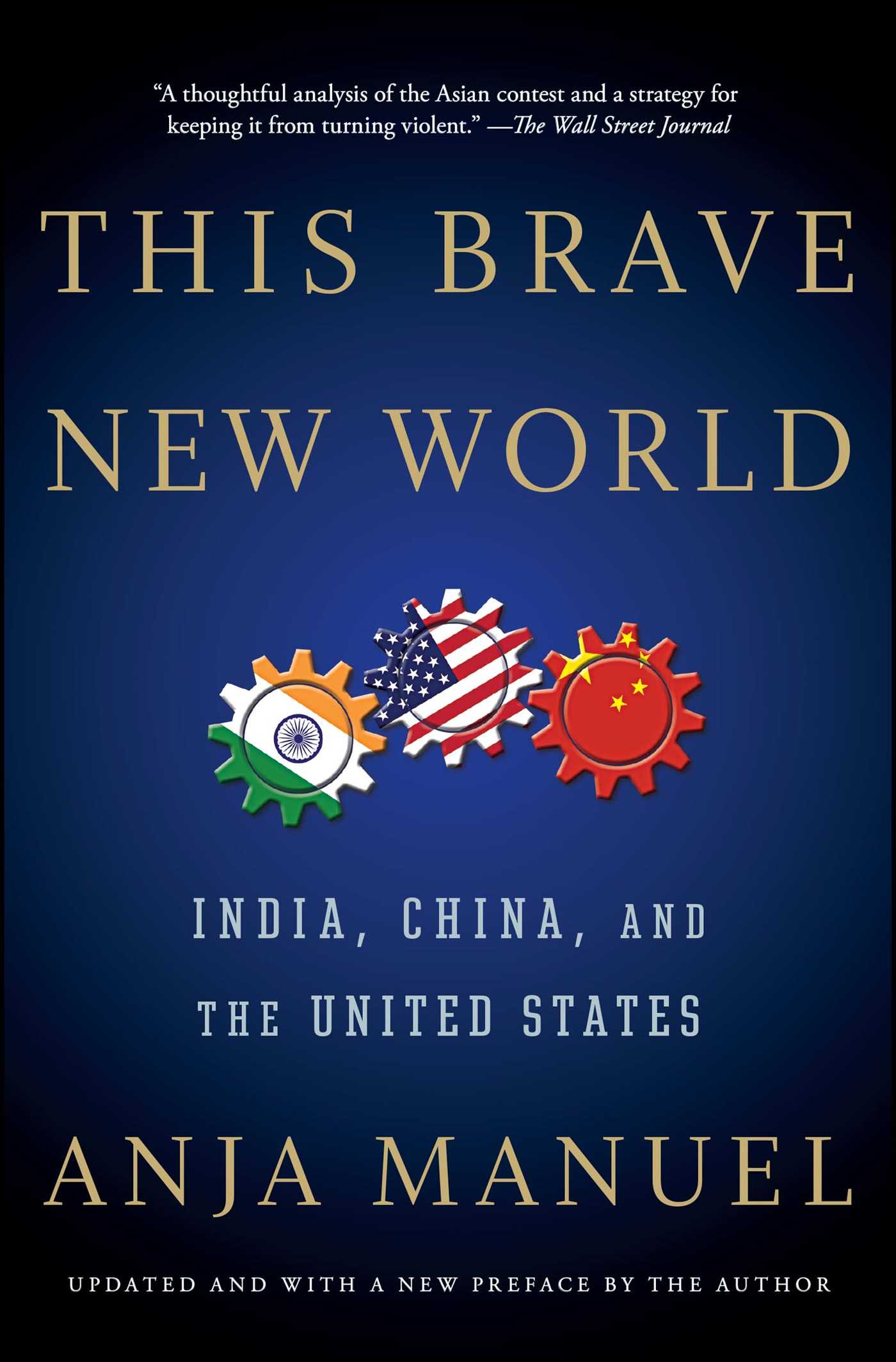
This Brave New World “By turns alarming and encouraging…Manuel delineates with clarity [why] the US must attend closely to…harmonious future relations with China and India†(Kirkus Reviews) and why our obsession with China (as once with Japan) is shortsighted. In the next decade and a half, China and India will become two of the world’s indispensable powers—whether they rise peacefully or not. During that time, Asia will surpass the combined strength of North America and Europe in economic might, population size, and military spending. Both India and China will have vetoes over many international decisions, from climate change to global trade, human rights, and business standards. From her front row view of this colossal shift, first at the State Department and now as an advisor to American business leaders, Anja Manuel escorts the reader on an intimate tour of the corridors of power in Delhi and Beijing. Her encounters with political and business leaders reveal how each country’s history and politics influences their conduct today. Through vibrant stories, she reveals how each country is working to surmount enormous challenges—from the crushing poverty of Indian slum dwellers and Chinese factory workers, to outrageous corruption scandals, rotting rivers, unbreathable air, and managing their citizens’ discontent. “Incisive…lively and accessible…Manual shows us that an optimistic path is possible: we can bring China and India along as partners“ (San Francisco Chronicle). We wring our hands about China, Manuel writes, while we underestimate India, which will be the most important country outside the West to shape China’s rise. Manuel shows us that a different path is possible—we can bring China and India along as partners rather than alienating one or both, and thus extend our own leadership in the world. This Brave New World offers “a thoughtful analysis…and a strategy for keeping it from turning violent†(The Wall Street Journal). POLITICAL SCIENCE,World,General
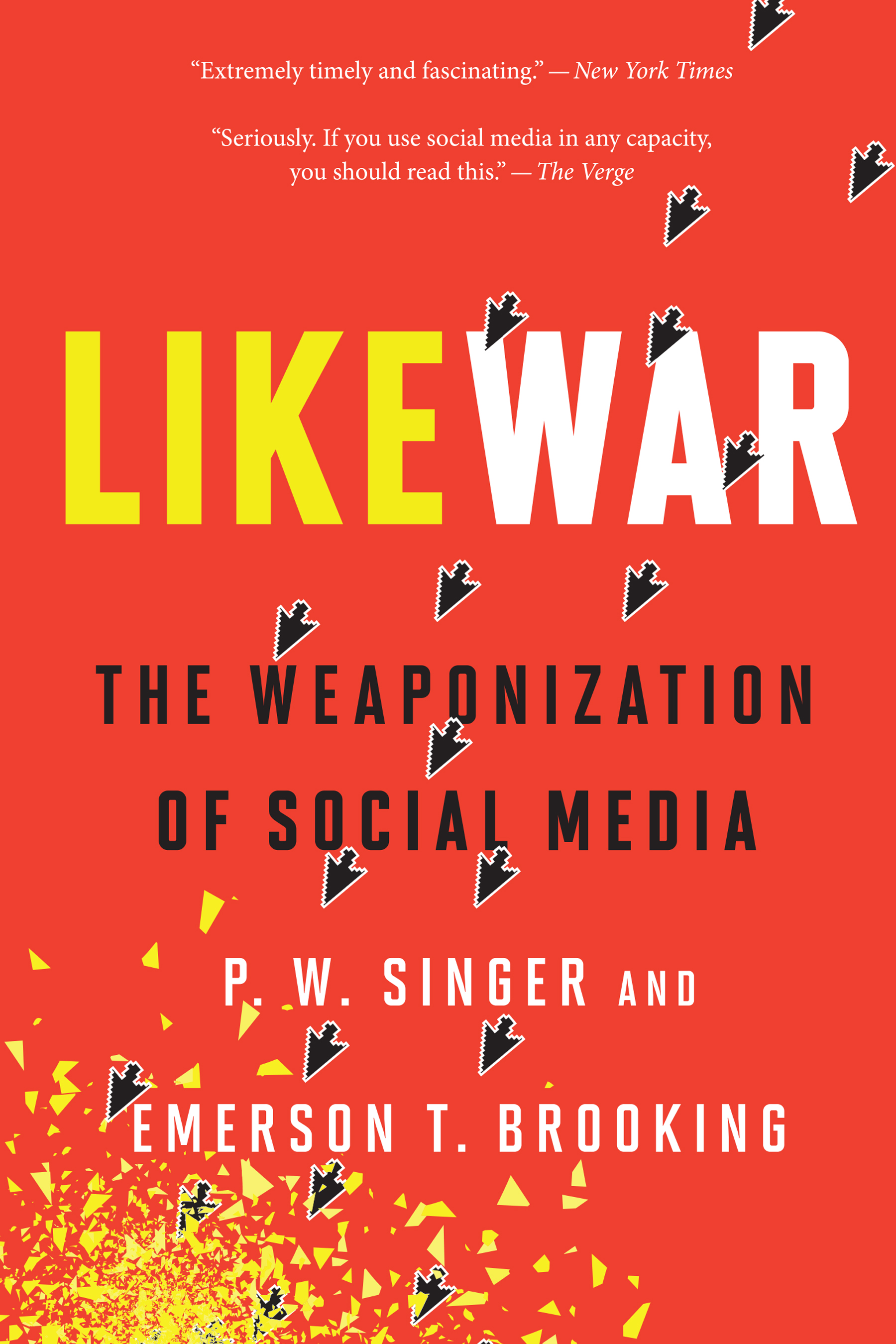
LikeWar Two defense experts investigate the present and future of conflict in a world where the front lines are only a click away. POLITICAL SCIENCE,World,General
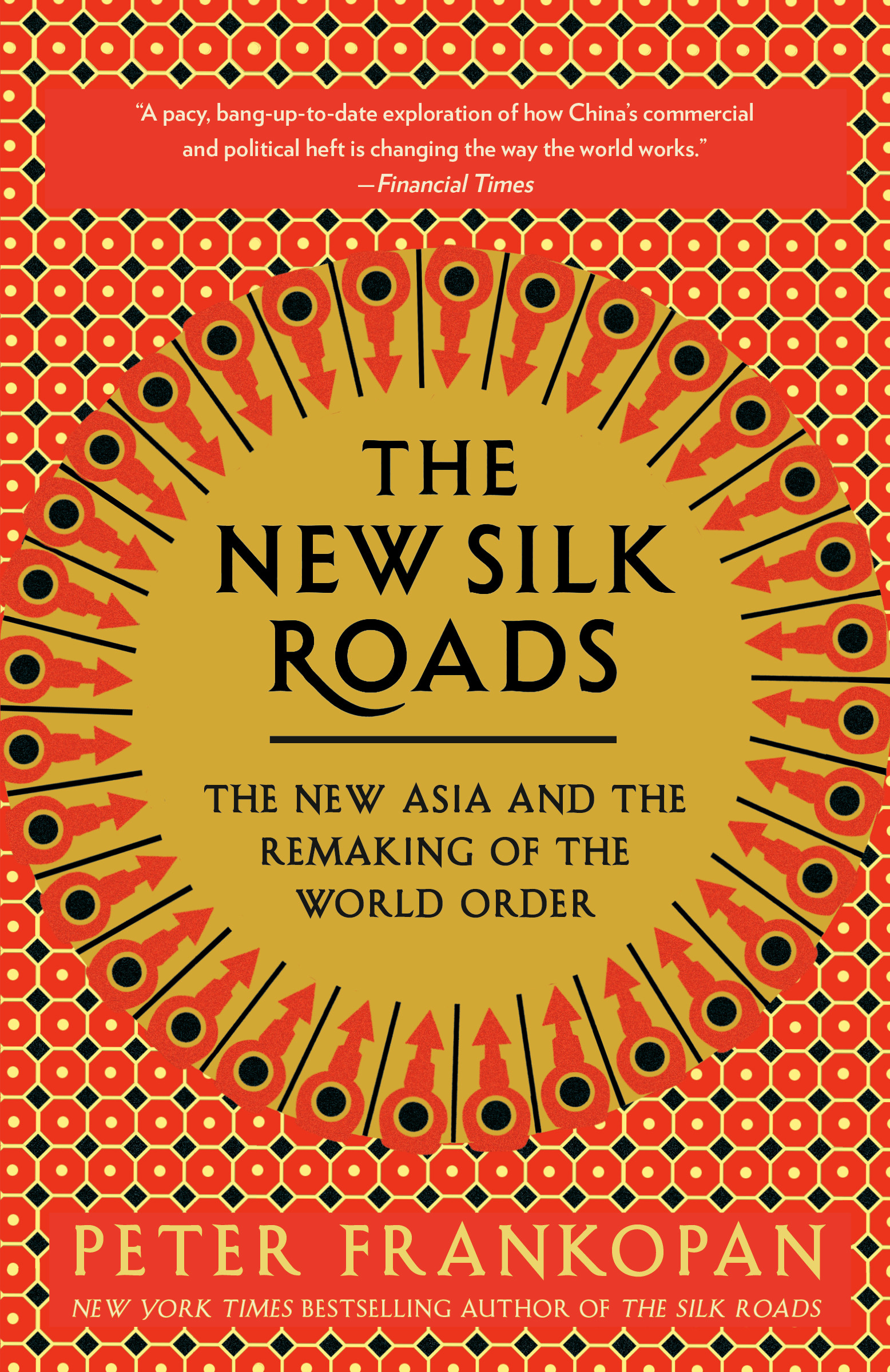
The New Silk Roads From the bestselling author of The Silk Roads comes an updated, timely, and visionary book about the dramatic and profound changes our world is undergoing right now—as seen from the perspective of the rising powers of the East. "All roads used to lead to Rome. Today they lead to Beijing." So argues Peter Frankopan in this revelatory new book. In the age of Brexit and Trump, the West is buffeted by the tides of isolationism and fragmentation. Yet to the East, this is a moment of optimism as a new network of relationships takes shape along the ancient trade routes. In The New Silk Roads, Peter Frankopan takes us on an eye-opening journey through the region, from China's breathtaking infrastructure investments to the flood of trade deals among Central Asian republics to the growing rapprochement between Turkey and Russia. This important book asks us to put aside our preconceptions and see the world from a new—and ultimately hopeful—perspective. POLITICAL SCIENCE,World,General
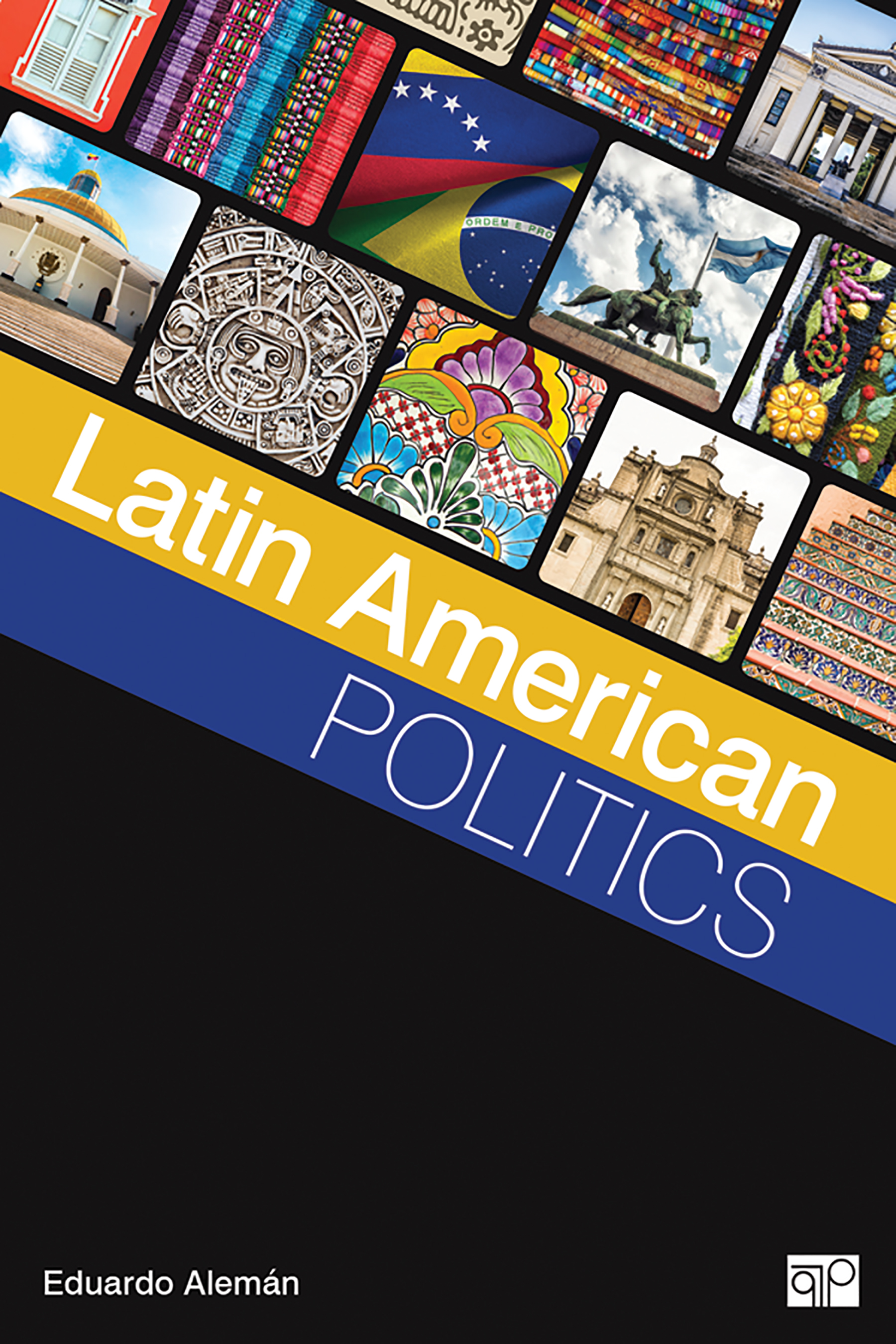
Latin American Politics While it is true that poverty, political instability, and economic under-performance continue to be major problems in Latin America, the region has made substantial progress in raising standards of living and overcoming military authoritarianism. Latin American Politics reflects just how much the region has changed in the last two decades. Eduardo Alemán draws on contemporary research in comparative studies on institutions, elections, and public opinion to highlight the big questions that political scientists seek to answer today: What are the causes of political instability? What factors have influenced changes in economic and gender inequality? What are the implications of different political institutions for political outcomes? POLITICAL SCIENCE,World,General
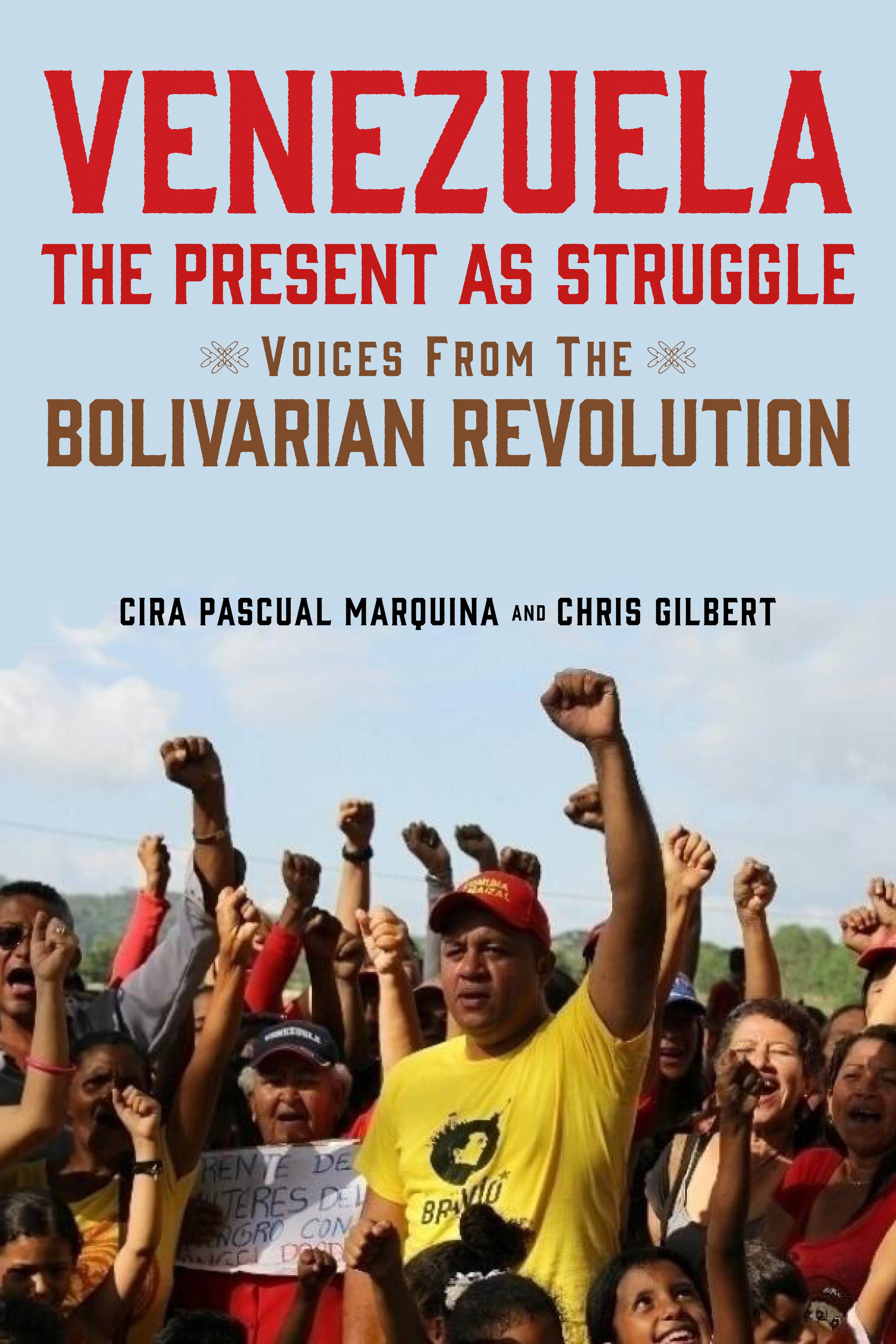
Venezuela, the Present as Struggle Reveals the revolutionary power of the Chavista grassroots movement Venezuela has been the stuff of frontpage news extravaganzas, especially since the death of Hugo Chavez. With predictable bias, mainstream media focus on violent clashes between opposition and government, coup attempts, hyperinflation, U.S. sanctions, and massive immigration. What is less known, however, is the story of what the Venezuelan people – especially the Chavista masses – do and think in these times of social emergency. Denying us their stories comes at a high price to people everywhere, because the Chavista bases are the real motors of the Bolivarian revolution. This revolutionary grassroots movement still aspires to the communal path to socialism that Chavez refined in his last years. Venezuela, the Present as Struggle is an eloquent testament to their lives.Comprised of a series of compelling interviews conducted by Cira Pascual Marquina, professor at the Bolivarian University, and contextualized by author Chris Gilbert, the book seeks to open a window on grassroots Chavismo itself in the wake of Chavez’s death. Feminist and housing activists, communards, organic intellectuals, and campesinos from around the country speak up in their own voices, defending the socialist project and pointing to what they see as revolutionary solutions to Venezuela’s current crisis. If the Venezuelan government has shown an impressive capacity to resist imperialism, it is the Chavista grassroots movement, as this book shows, that actually defends socialism as the only coherent project of national liberation. POLITICAL SCIENCE,World,General
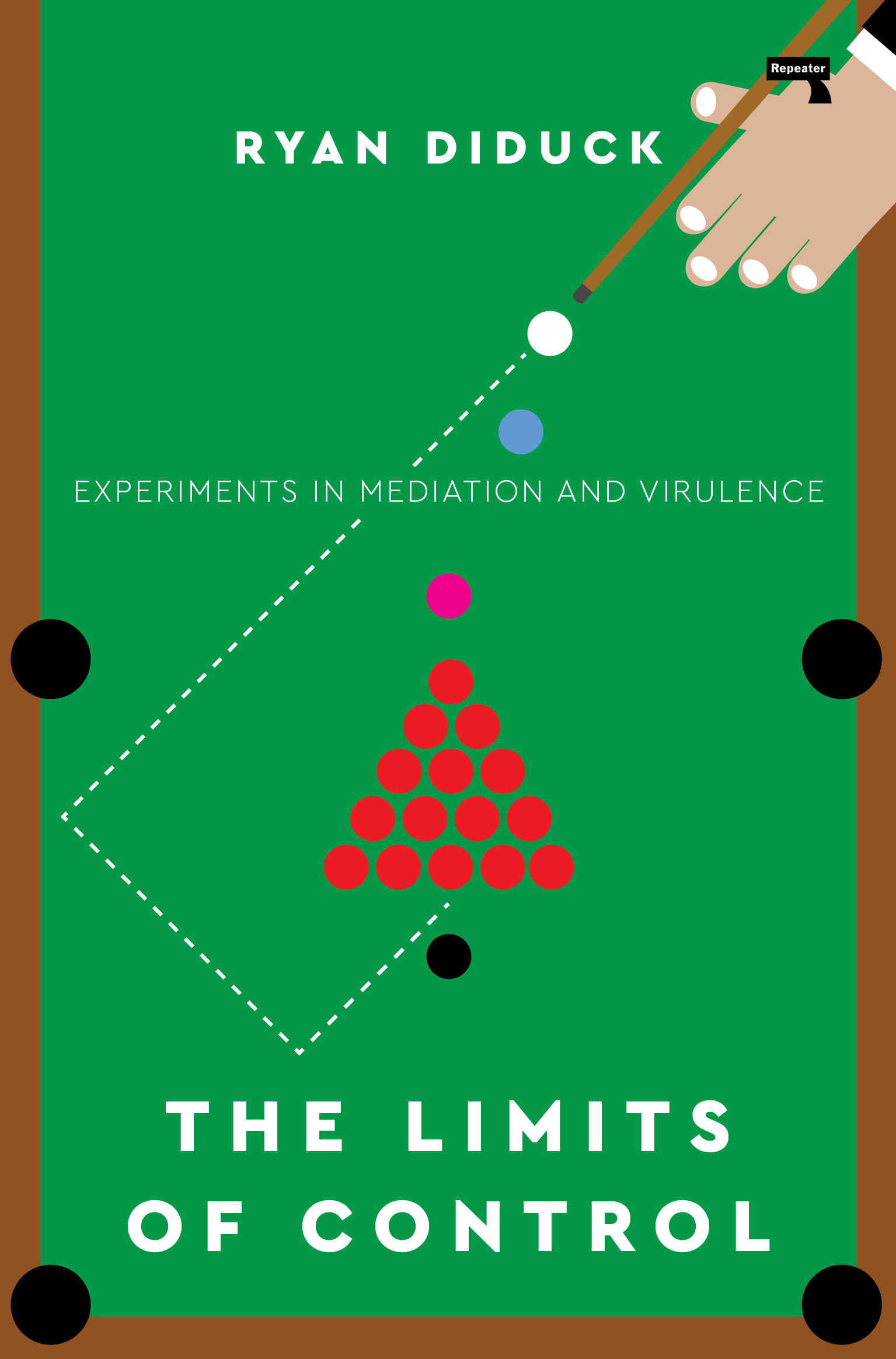
The Limits of Control Ryan Diduck turns his attention to control societies and their protocols in the wake of the global COVID-19 pandemic. What are the political implications of government measures to combat Coronavirus? The end of the world as we know it is no longer imaginary. Severe acute respiratory syndrome Coronavirus 2 (also known as SARS-CoV-2 or COVID-19) is a potent virus that is upturning nearly every aspect of life on earth. But the novel Coronavirus is more than just a virus. It is a marketplace and media event, too, broadcasting at speed, oscillating against the transmission of its mediations. Ultimately, COVID-19 is the pretext upon which nations around the world have enacted social controls of varying severity, strictly limiting the communication, movement, and daily activities of billions of people. This could be a moment of overwhelming consolidation of capital. Or it could further reveal the cracks in a system which has exacerbated the coronavirus pandemic. We are rapidly approaching the limits of control. In the tradition of William S. Burroughs, Naomi Klein, Mark Fisher, and other key theorists of discipline and jurisdiction, The Limits of Control offers a timely new analysis of control societies, and a sibylline roadmap for living together in a hypervirulent world. What we imagine from now on has never mattered more. POLITICAL SCIENCE,World,General
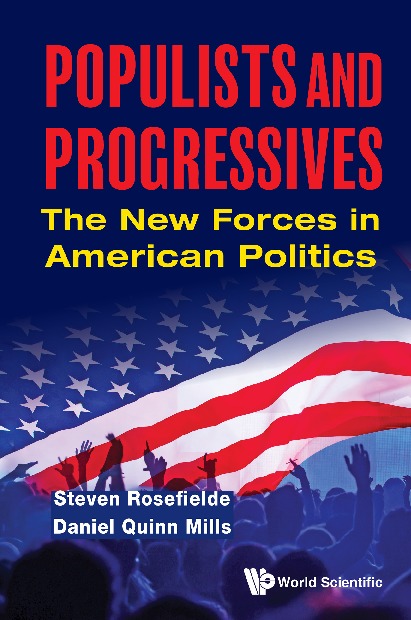
Populists And Progressives Populists and Progressives alerts readers to dramatic changes in the ideological and political structure of America's Democratic and Republican parties roiling Washington and shaping the 2020 presidential election. America now has four distinct contentious political orientations: progressive, liberal, conservative and populist. The least well understood are the progressives, whose programs are often confused with socialism, and populists stigmatized as reactionaries. Each has its own agenda and presses programs that are incompatible with one another, auguring protracted strife and paralysis. The book carefully elaborates the substance of each movement and analyses the social, political and economic forces driving them. It assesses their staying power and prospects in the 2020 presidential election. The analysis reveals that most contemporary American political commentary is intensely partisan and relies on obsolete notions of Democrat and Republican party doctrine and rivalry, obscuring the transformation of American society, politics and economy. Populists and Progressives assists readers to dispel the fog, allowing them to judge the present danger and help in the search for consensus solutions. POLITICAL SCIENCE,World,General

The Justice Cascade Acclaimed scholar Kathryn Sikkink examines the important and controversial new trend of holding political leaders criminally accountable for human rights violations. Grawemeyer Award winner Kathryn Sikkink offers a landmark argument for human rights prosecutions as a powerful political tool. She shows how, in just three decades, state leaders in Latin America, Europe, and Africa have lost their immunity from any accountability for their human rights violations, becoming the subjects of highly publicized trials resulting in severe consequences. This shift is affecting the behavior of political leaders worldwide and may change the face of global politics as we know it. Drawing on extensive research and illuminating personal experience, Sikkink reveals how the stunning emergence of human rights prosecutions has come about; what effect it has had on democracy, conflict, and repression; and what it means for leaders and citizens everywhere, from Uruguay to the United States. The Justice Cascade is a vital read for anyone interested in the future of world politics and human rights. POLITICAL SCIENCE,World,General
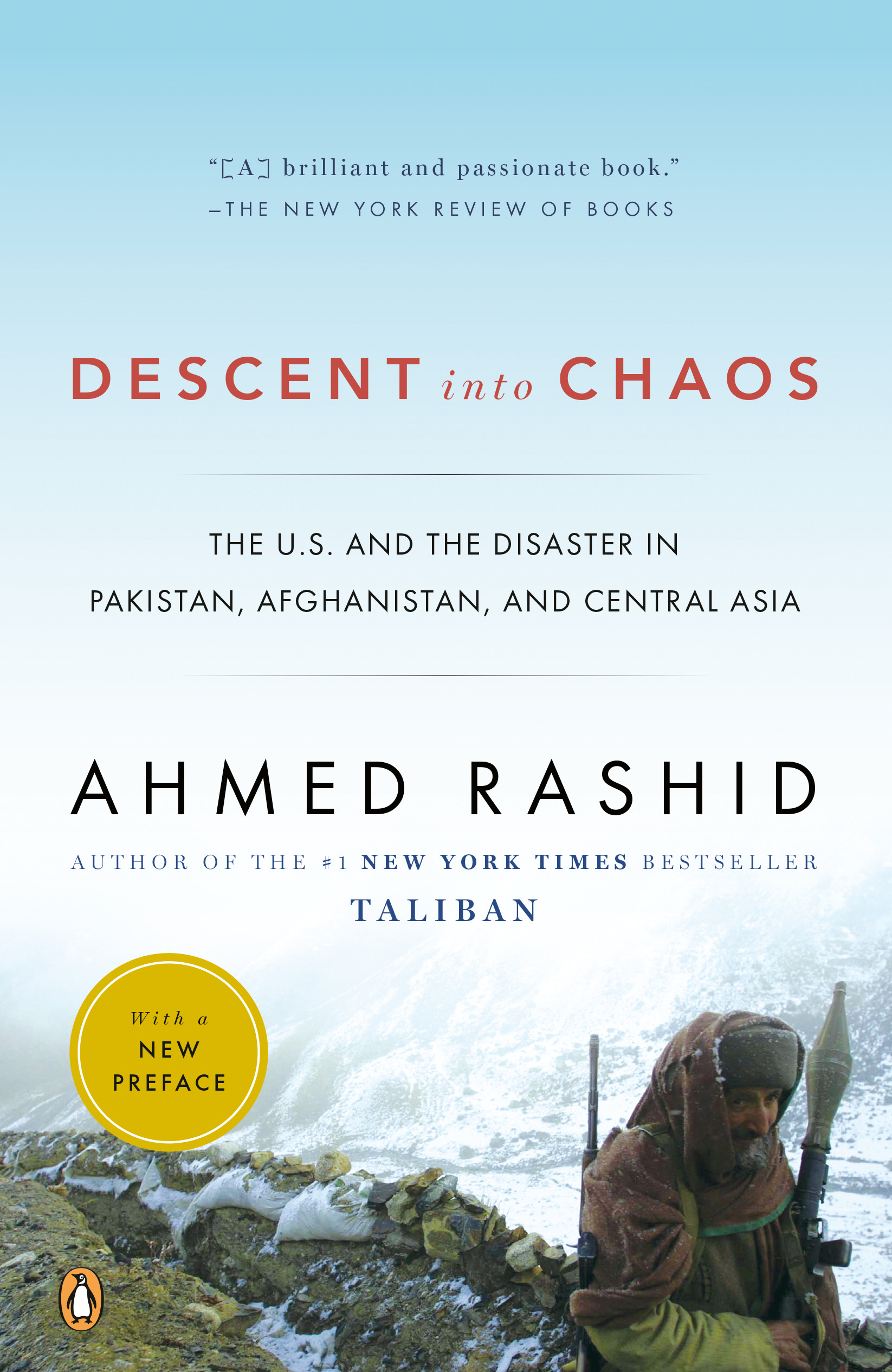
Descent into Chaos The #1 New York Times bestselling author provides a shocking analysis of the crisis in Pakistan and the renewed radicalism threatening Afghanistan and the West. Ahmed Rashid is “Pakistan’s best and bravest reporter” (Christopher Hitchens). His unique knowledge of this vast and complex region allows him a panoramic vision and nuance that no Western writer can emulate. His book Taliban first introduced American readers to the brutal regime that hijacked Afghanistan and harbored the terrorist group responsible for the 9/11 attacks. Now, Rashid examines the region and the corridors of power in Washington and Europe to see how the promised nation building in these countries has pro-gressed. His conclusions are devastating: An unstable and nuclear-armed Pakistan, a renewed al’ Qaeda profiting from a booming opium trade, and a Taliban resurgence and reconquest. While Iraq continues to attract most of American media and military might, Rashid argues that Pakistan and Afghanistan are where the conflict will finally be played out and that these failing states pose a graver threat to global security than the Middle East. Benazir Bhutto’s assassination and the crisis in Pakistan are only the beginning. Rashid assesses what her death means for the region and the future. Rashid has unparalleled access to the figures in this global drama, and provides up-to-the-minute analysis better than anyone else. Descent Into Chaos will do for Central Asia what Thomas Rick’s Fiasco did for Iraq — offer a blistering critique of the Bush administration and an impassioned call to correct our failed strategy in the region. POLITICAL SCIENCE,World,Middle Eastern

The Dressmaker of Khair Khana The New York Times bestseller, written by a former reporter for ABC News, that People magazine called “a transporting, enlightening book†tells the story of a fearless young entrepreneur who brought hope to the lives of dozens of women in war-torn Afghanistan Former ABC journalist Gayle Tzemach Lemmon tells the riveting true story of Kamila Sidiqi and other women of Afghanistan in the wake of the Taliban’s fearful rise to power. In what Greg Mortenson, author of Three Cups of Tea, calls “one of the most inspiring books I have ever read,†Lemmon recounts with novelistic vividness the true story of a fearless young woman who not only reinvented herself as an entrepreneur to save her family but, in the face of ferocious opposition, brought hope to the lives of dozens of women in war-torn Kabul. POLITICAL SCIENCE,World,Middle Eastern

An Introduction to Middle East Politics An exciting new text that moves beyond the Arab-Israeli conflict to approach the study of the Middle East in a broader and more interconnected manner, with full coverage of the recent uprisings. Includes chapters on contemporary topics such as social media and human rights. POLITICAL SCIENCE,World,Middle Eastern
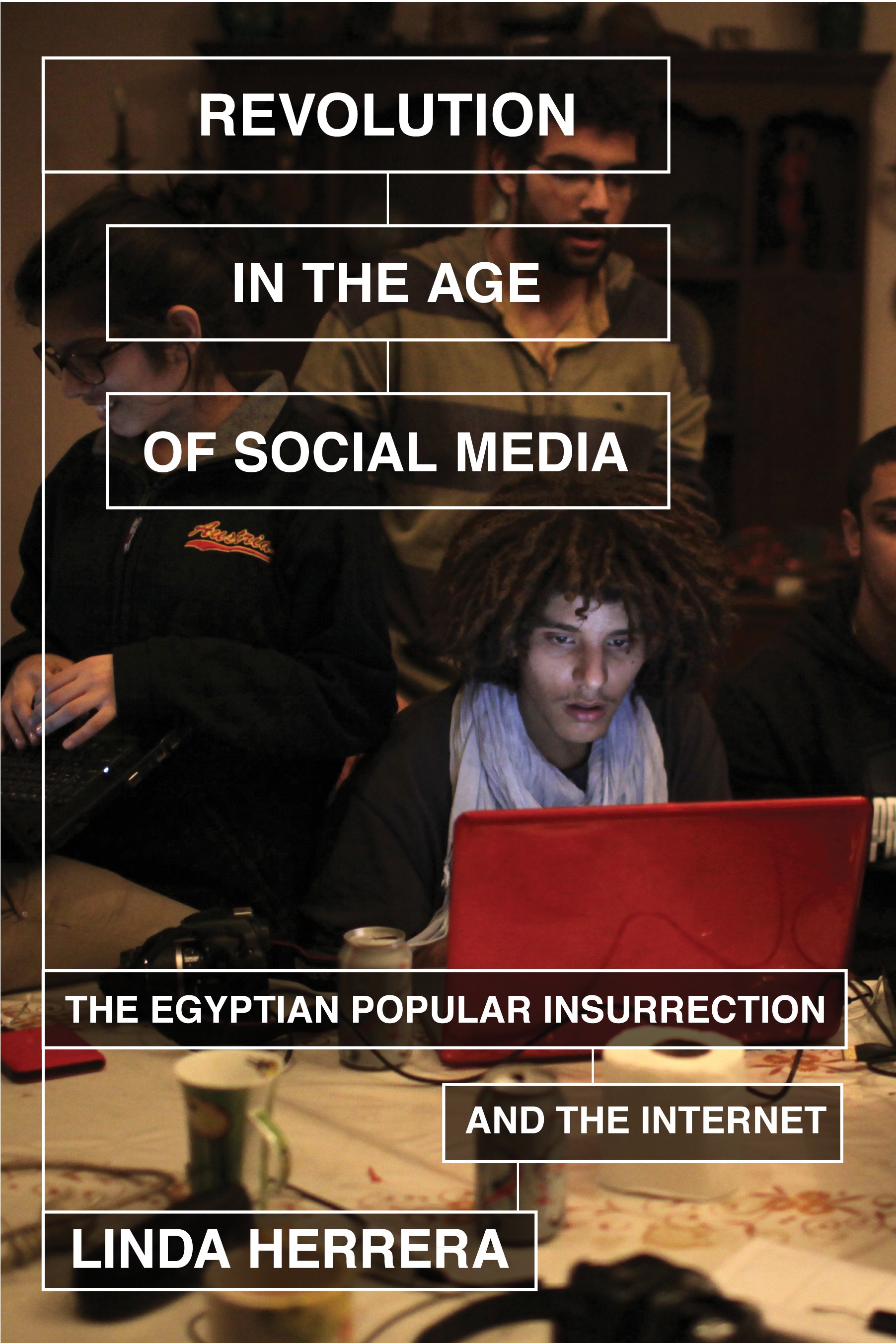
Revolution in the Age of Social Media Egypt's January 25 revolution was triggered by a Facebook page and played out both in virtual spaces and the streets. Social media serves as a space of liberation, but it also functions as an arena where competing forces vie over the minds of the young as they battle over ideas as important as the nature of freedom and the place of the rising generation in the political order. This book provides piercing insights into the ongoing struggles between people and power in the digital age. POLITICAL SCIENCE,World,Middle Eastern

Saudi Arabia Exposed Saudi Arabia: land of oil, terrorism, Islamic fundamentalism, and a crucial American ally. As the only Western journalist to have extensively worked in the Saudi Kingdom, John R. Bradley is uniquely able to expose the turmoil that is shaking the House of Saud to its foundations. From the heart of the secretive Islamic kingdom's urban centers to its most remote mountainous terrain, from the homes of royalty to the slums of its poorest inhabitants, he provides intimate details and reveals underlying regional, religious, and tribal rivalries. Bradley highlights tensions generated by social change, focuses on the educational system, the increasing restlessness of Saudi youth faced with limited opportunities for cultural and political expression, and the predicament of Saudi women seeking opportunities but facing constraints. What are the implications for the Sauds and the West? This book offers a startling look at the present predicament and a troubling view of the future. POLITICAL SCIENCE,World,Middle Eastern
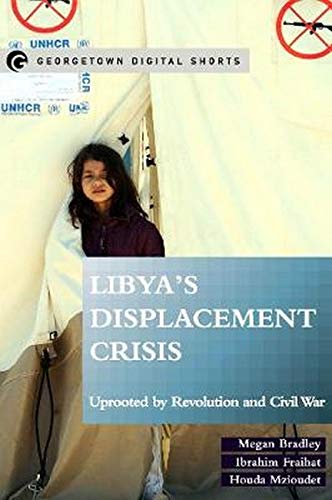
Libya's Displacement Crisis This publication explores the political, humanitarian, and human rights implications of the unprecedented displacement crisis in Libya since the fall of the Gaddafi regime and the surging civil war. Drawing on in-depth interviews with policymakers, practitioners, and displaced Libyans inside and outside the country, the authors present a clear-eyed assessment of the factors contributing to displacement and suggest avenues to improve assistance strategies and to support durable solutions for displaced Libyans. POLITICAL SCIENCE,World,Middle Eastern

Understanding Arabs NEW 6TH EDITION NOW AVAILABLE This Fifth Editon of the highly successful guide to arab society - published in line with the Arab Spring. The perfect introduction to contemporary Arab culture for those who want to understand today's headlines and the complex events playing out on the world stage. From the rise of fundamentalism to the historically uneasy relationship between the Arab World and the West, Margaret Nydell has expanded her highly respected book to bring today's complex issues into clearer focus. Understanding Arabs introduces the elements of Arab culture and Islam in an even-handed, unbiased style. The book covers such topics as beliefs and values; religion and society; the role of the family; friends and strangers; men and women; social formalities and etiquette; and communication styles. POLITICAL SCIENCE,World,Middle Eastern

Fiqh al-Aqalliyy?t This book examines the development of a contemporary internal debate among Muslim minorities living in Western Europe and North America to establish a specific form of Islamic jurisprudence. Fiqh al-aqalliyyat attempts to strike a balance between Muslim's religious commitments and their civic identity as citizens in Western liberal states. POLITICAL SCIENCE,World,Middle Eastern

The New Arab Wars Less than twenty-four months after the hope-filled Arab uprising, the popular movement had morphed into a dystopia of resurgent dictators, failed states, and civil wars. Egypt's epochal transition to democracy ended in a violent military coup. Yemen and Libya collapsed into civil war, while Bahrain erupted in smothering sectarian repression. Syria proved the greatest victim of all, ripped apart by internationally fueled insurgencies and an externally supported, bloody-minded regime. Amidst the chaos, a virulently militant group declared an Islamic State, seizing vast territories and inspiring terrorism across the globe. What happened? The New Arab Wars is a profound illumination of the causes of this nightmare. It details the costs of the poor choices made by regional actors, delivers a scathing analysis of Western misreadings of the conflict, and condemns international interference that has stoked the violence. Informed by commentators and analysts from the Arab world, Marc Lynch's narrative of a vital region's collapse is both wildly dramatic and likely to prove definitive. Most important, he shows that the region's upheavals have only just begun -- and that the hopes of Arab regimes and Western policy makers to retreat to old habits of authoritarian stability are doomed to fail. POLITICAL SCIENCE,World,Middle Eastern

Iranian Foreign Policy during Ahmadinejad Written for scholars and practitioners puzzled by Iran's foreign policy choices, this book argues that Iran's foreign policy behavior is best understood in the context of the regime's foreign policy ideology, which is rooted in a conception of Iran as a nation changed by the 1979 Revolution and an example to other nations in a changing world. POLITICAL SCIENCE,World,Middle Eastern
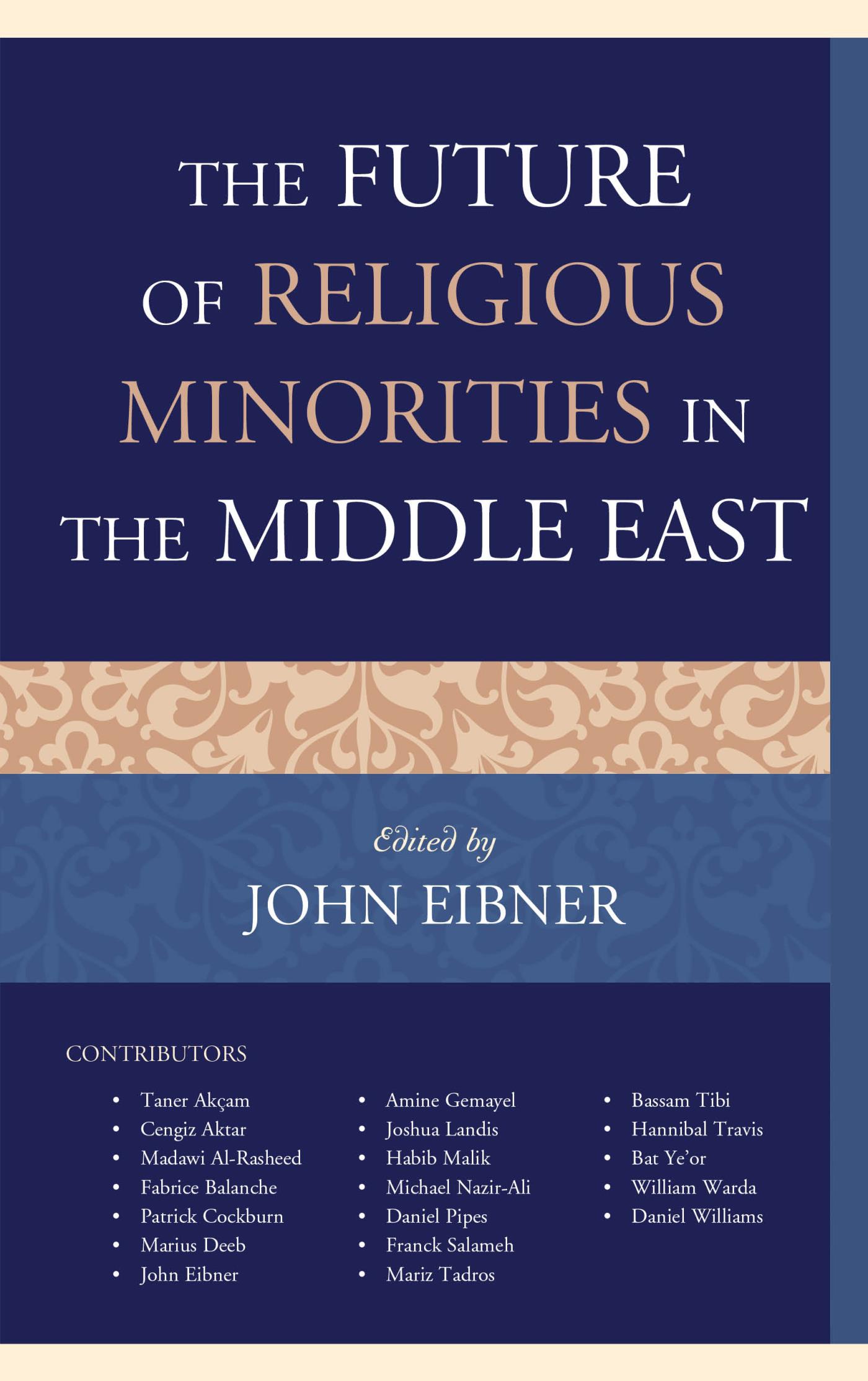
The Future of Religious Minorities in the Middle East This book discusses the rapid erosion of social pluralism and the concomitant “religious cleaning†of religious minorities in the Middle East. It focuses on five crucial years between the “Arab Spring†uprisings of 2011 and the U.S. government’s genocide determination in 2016 regarding religious minorities in the Middle East. POLITICAL SCIENCE,World,Middle Eastern
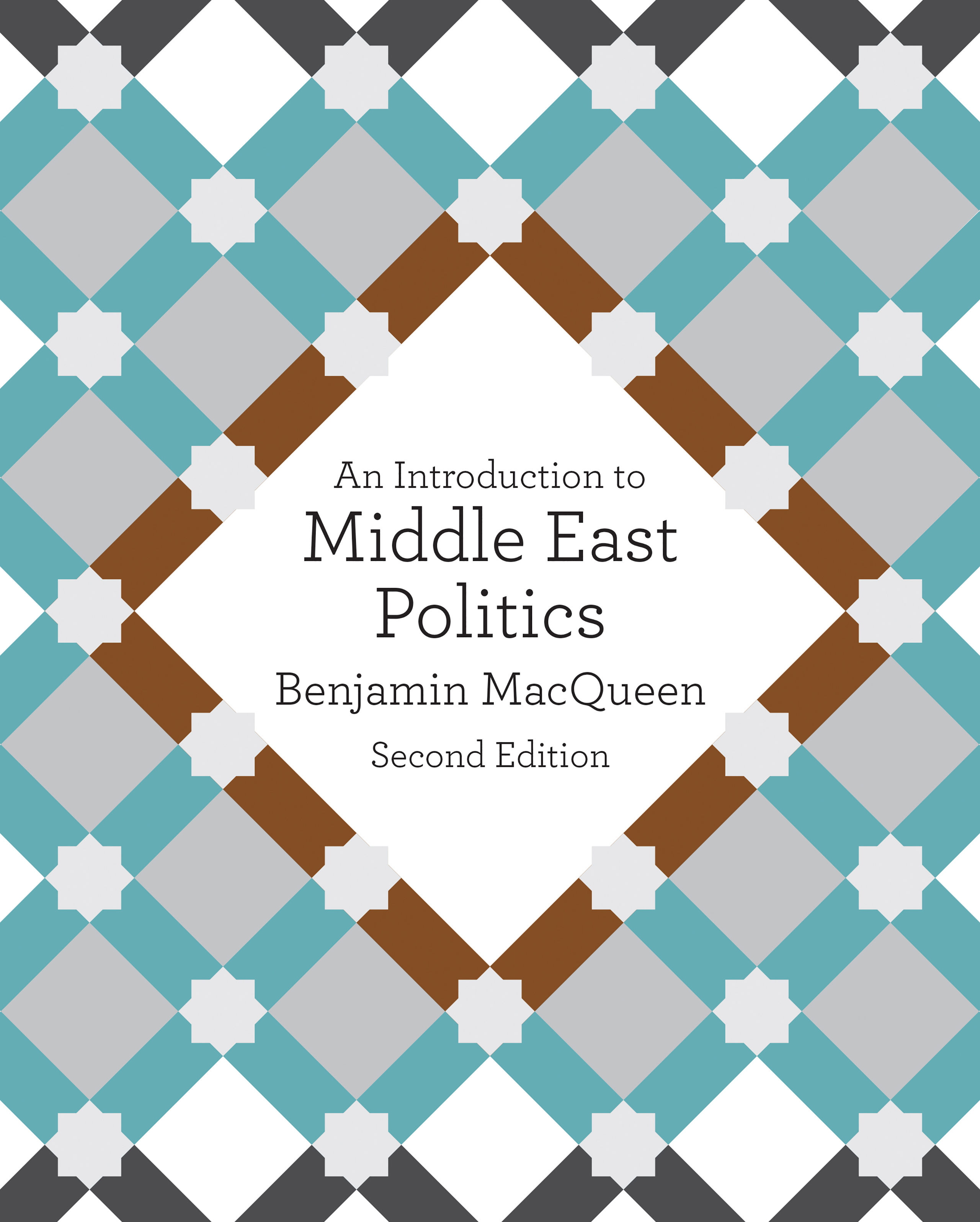
An Introduction to Middle East Politics This new edition of An Introduction to Middle East Politics continues to provide an expansive survey of Middle East politics, thoroughly revised and restructured in response to events currently taking place. Written in a lively and accessible manner, MacQueen takes students on a tour of the region’s modern political history up to the present, clearly signposting key events and issues. POLITICAL SCIENCE,World,Middle Eastern

State of Repression A new account of modern Iraqi politics that overturns the conventional wisdom about its sectarian divisions How did Iraq become one of the most repressive dictatorships of the late twentieth century? The conventional wisdom about Iraq's modern political history is that the country was doomed by its diverse social fabric. But in State of Repression, Lisa Blaydes challenges this belief by showing that the country's breakdown was far from inevitable. At the same time, she offers a new way of understanding the behavior of other authoritarian regimes and their populations. Drawing on archival material captured from the headquarters of Saddam Hussein's ruling Ba'th Party in the wake of the 2003 US invasion, Blaydes illuminates the complexities of political life in Iraq, including why certain Iraqis chose to collaborate with the regime while others worked to undermine it. She demonstrates that, despite the Ba'thist regime's pretensions to political hegemony, its frequent reliance on collective punishment of various groups reinforced and cemented identity divisions. In addition, a series of costly external shocks to the economy--resulting from fluctuations in oil prices and Iraq's war with Iran—weakened the capacity of the regime to monitor, co-opt, coerce, and control factions of Iraqi society. In addition to calling into question the common story of modern Iraqi politics, State of Repression offers a new explanation of why and how dictators repress their people in ways that can inadvertently strengthen regime opponents. POLITICAL SCIENCE,World,Middle Eastern
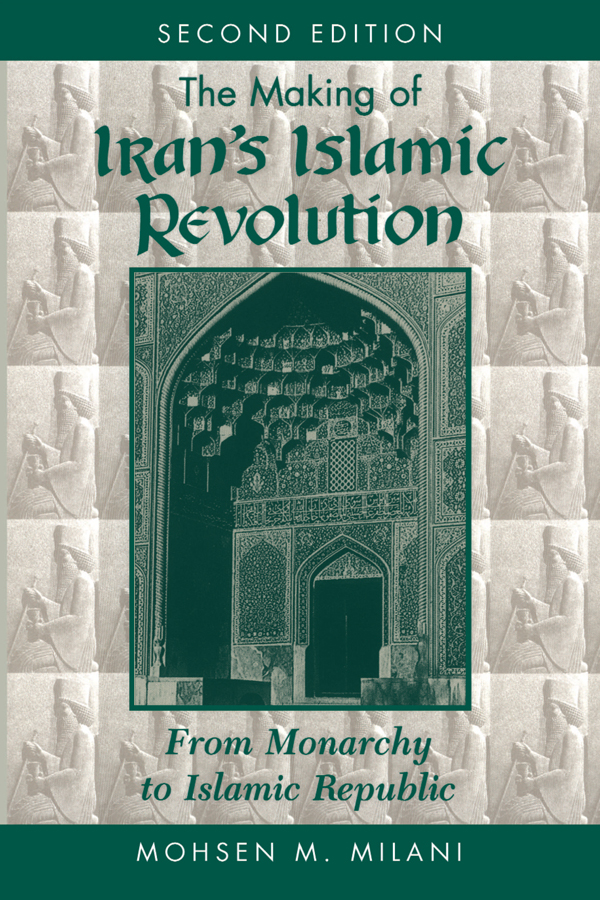
The Making Of Iran's Islamic Revolution In this fully revised and expanded second edition, Dr. Milani offers new insights into the causes and profound consequences of Iran's Islamic Revolution. Drawing on dozens of personal interviews with the officials of the Islamic Republic and on recently released documents, he presents a provocative analysis of the dynamics and characteristics of factional politics in Islamic Iran. Among the new issues covered are the events leading up to the Teheran hostage crisis, Ayatollah Khomeini's life and writings, President Rafsanjani's activities against the Shah, Rafsanjani's recent reforms, Iran's involvement in the Kuwaiti crisis, and the domestic and foreign policy challenges facing Iran in the post?Cold War era.The second edition is specifically revised for use as a text for courses dealing with Iran, the Middle East, and revolutionary movements. POLITICAL SCIENCE,World,Middle Eastern
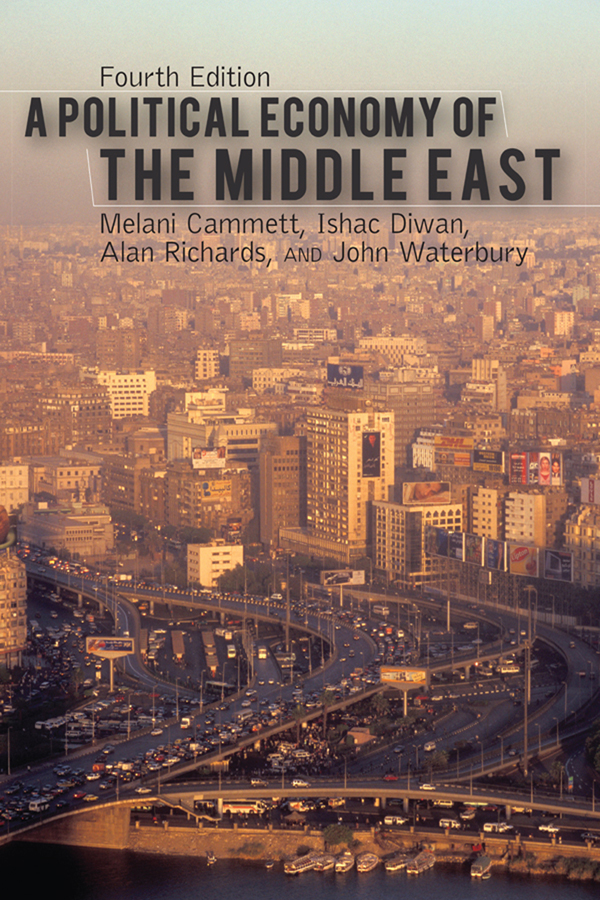
A Political Economy of the Middle East A Political Economy of the Middle East is the most comprehensive analysis of developments in the political economy of the region over the past several decades, examining the interaction of economic development processes, state systems and policies, and social actors in the Middle East. The fourth edition, with new authors Melani Cammett and Ishac Diwan, has been thoroughly revised, with two new introductory chapters that provide an updated framework with which to understand and study the many changes in demography, education, labor markets, urbanization, water and agriculture, and international labor migration in the recent years. The new edition also includes: a new chapter that charts the political economy of the Gulf states and, in particular, the phenomenal growth of oil economies; a new chapter on the rise of "crony capitalism;" and increased coverage of the changes in civil society and social movements in the region, including an exploration of the causes, dynamics, consequences, and aftermath of the Arab uprisings. POLITICAL SCIENCE,World,Middle Eastern

The Qur'an's Reformation of Judaism and Christianity This volume explores the relationship between the Qur’an and the Jewish and Christian traditions, considering aspects of continuity and reform. The chapters examine the Qur’an’s retelling of biblical narratives, as well as its reaction to a wide array of topics that mark Late Antique religious discourse, including eschatology and ritual purity, prophetology and paganism, and heresiology and Christology. Twelve emerging and established scholars explore the many ways in which the Qur’an updates, transforms, and challenges religious practice, beliefs, and narratives that Late Antique Jews and Christians had developed in dialogue with the Bible. The volume establishes the Qur’an’s often unique perspective alongside its surprising continuity with Judaism and Christianity. Chapters focus on individual suras and on intra-Qur’anic parallels, on the Qur’an’s relationship to pre-Islamic Arabian culture, on its intertextuality and its literary intricacy, and on its legal and moral framework. It illustrates a move away from the problematic paradigm of cultural influence and instead emphasizes the Qur’an’s attempt to reform the religious landscape of its time. The Qur'an's Reformation of Judaism and Christianity offers new insight into the Islamic Scripture as a whole and into recent methodological developments, providing a compelling snapshot of the burgeoning field of Qur’anic studies. It is a key resource for students and scholars interested in religion, Islam, and Middle Eastern Studies. POLITICAL SCIENCE,World,Middle Eastern
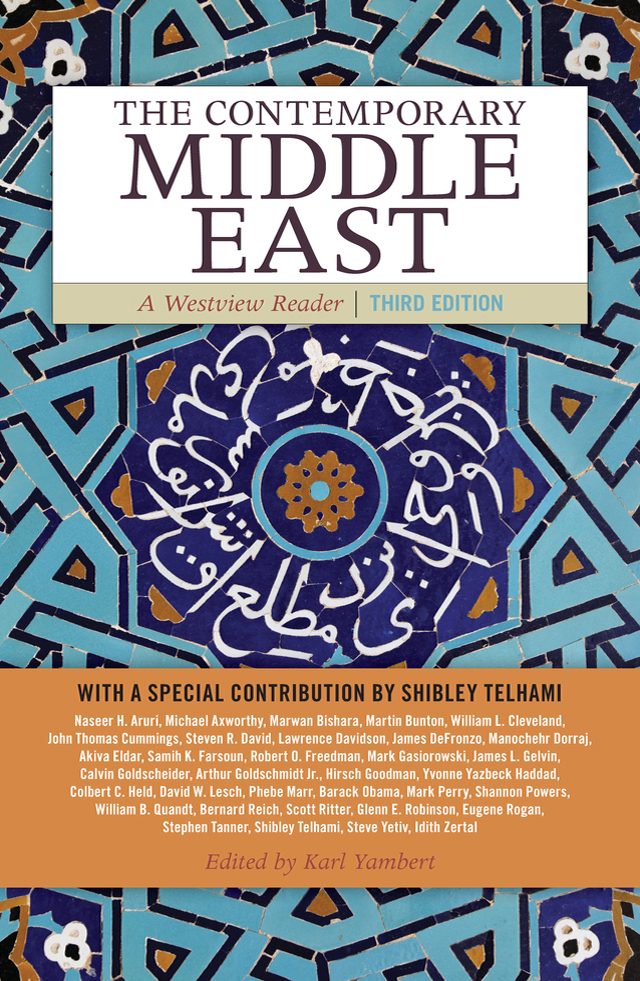
The Contemporary Middle East The Contemporary Middle East provides an accessible introduction to the region's most pressing concerns and enduring conflicts. It includes provocative contributions by an impressive array of leading scholars, journalists, and policy advisors. Contributors include notable academic authors Arthur Goldschmidt Jr., the late William L. Cleveland, Shibley Telhami, David W. Lesch, Bernard Reich, and Phebe Marr, complemented by selections from recent general-interest books by Marwan Bishara, Mark Perry, and Eugene Rogan, among others. With twelve new chapters, the third edition is a probing examination of the current affairs of the Middle East. Its multiple readings on strategic pairings of topics (Israel and the Palestinians, Iraq and Iran, Egypt and Syria) illuminate the region's key issues from a variety of perspectives. Part- and chapter-opening summaries help establish background and context, and a new concluding chapter by Shibley Telhami, written specifically for this volume, candidly addresses fundamental questions about the United States and the Middle East today. Student resources include an annotated table of contents, a select bibliography, a glossary, brief biographies of notable persons, a chronology, and a summary of recent events, in addition to numerous maps. POLITICAL SCIENCE,World,Middle Eastern
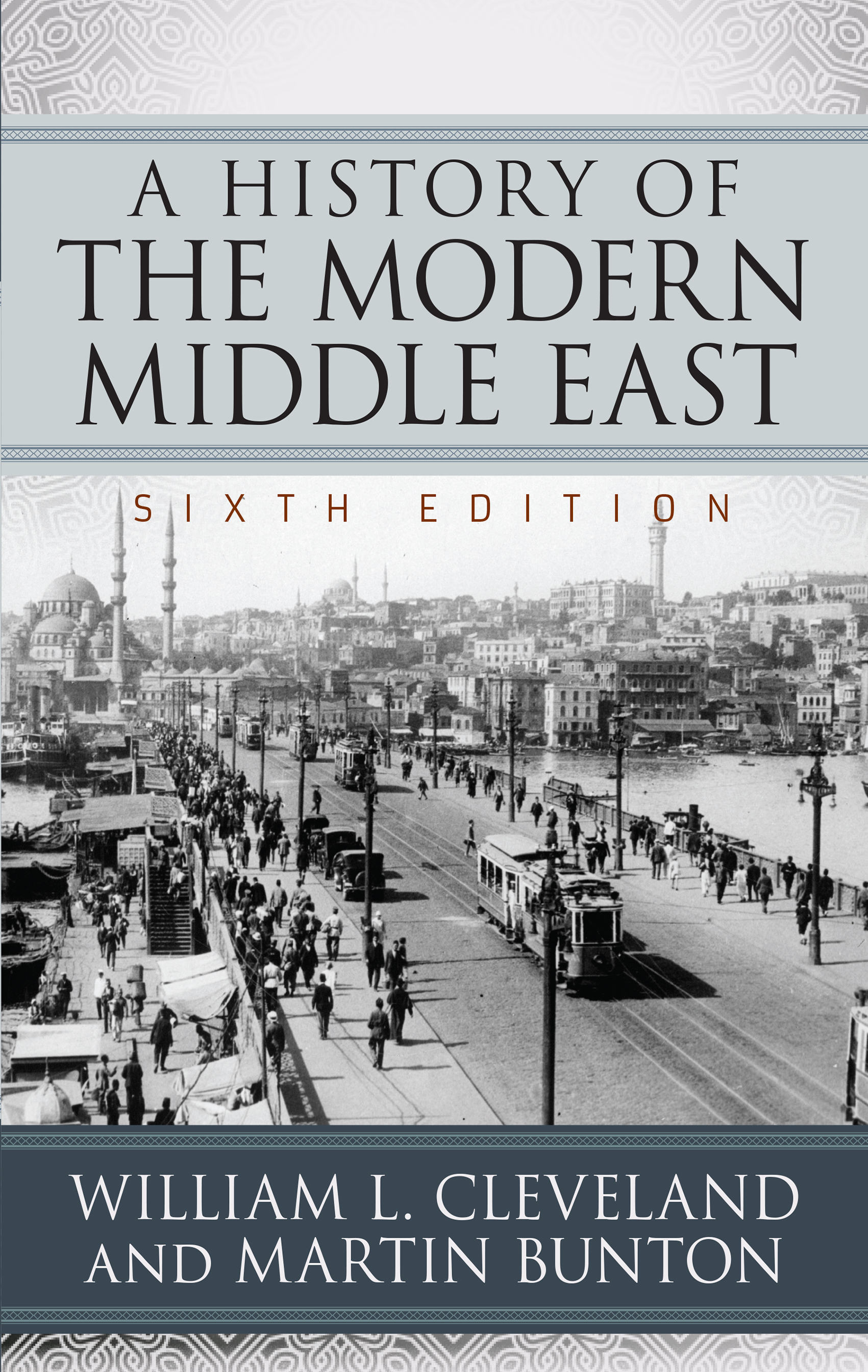
A History of the Modern Middle East A History of the Modern Middle East examines the profound and often dramatic transformations of the region in the past two centuries, from the Ottoman and Egyptian reforms, through the challenge of Western imperialism, to the impact of US foreign policies. Built around a framework of political history, while also carefully integrating social, cultural, and economic developments, this expertly crafted account provides readers with the most comprehensive, balanced and penetrating analysis of the modern Middle East. The sixth edition has been revised to provide a thorough account of the major developments since 2012, including the tumultuous aftermath of the Arab uprisings, the sectarian conflict in Iraq and civil war in Syria that led to the rise of ISIS, the crises in Libya and Yemen, and the United States' nuclear talks with Iran. With brand-new timelines in each part, updated select bibliographies, and expanded online instructor resources, A History of the Modern Middle East remains the quintessential text for courses on Middle East history. POLITICAL SCIENCE,World,Middle Eastern

The Buried A National Book Critics Circle Award Finalist "Extraordinary...Sensitive and perceptive, Mr. Hessler is a superb literary archaeologist, one who handles what he sees with a bit of wonder that he gets to watch the history of this grand city unfold, one day at a time.” —Wall Street Journal From the acclaimed author of River Town and Oracle Bones, an intimate excavation of life in one of the world's oldest civilizations at a time of convulsive change Drawn by a fascination with Egypt's rich history and culture, Peter Hessler moved with his wife and twin daughters to Cairo in 2011. He wanted to learn Arabic, explore Cairo's neighborhoods, and visit the legendary archaeological digs of Upper Egypt. After his years of covering China for The New Yorker, friends warned him Egypt would be a much quieter place. But not long before he arrived, the Egyptian Arab Spring had begun, and now the country was in chaos. In the midst of the revolution, Hessler often traveled to digs at Amarna and Abydos, where locals live beside the tombs of kings and courtiers, a landscape that they call simply al-Madfuna: "the Buried." He and his wife set out to master Arabic, striking up a friendship with their instructor, a cynical political sophisticate. They also befriended Peter's translator, a gay man struggling to find happiness in Egypt's homophobic culture. A different kind of friendship was formed with the neighborhood garbage collector, an illiterate but highly perceptive man named Sayyid, whose access to the trash of Cairo would be its own kind of archaeological excavation. Hessler also met a family of Chinese small-business owners in the lingerie trade; their view of the country proved a bracing counterpoint to the West's conventional wisdom. Through the lives of these and other ordinary people in a time of tragedy and heartache, and through connections between contemporary Egypt and its ancient past, Hessler creates an astonishing portrait of a country and its people. What emerges is a book of uncompromising intelligence and humanity--the story of a land in which a weak state has collapsed but its underlying society remains in many ways painfully the same. A worthy successor to works like Rebecca West's Black Lamb and Grey Falcon and Bruce Chatwin's The Songlines, The Buried bids fair to be recognized as one of the great books of our time. POLITICAL SCIENCE,World,Middle Eastern
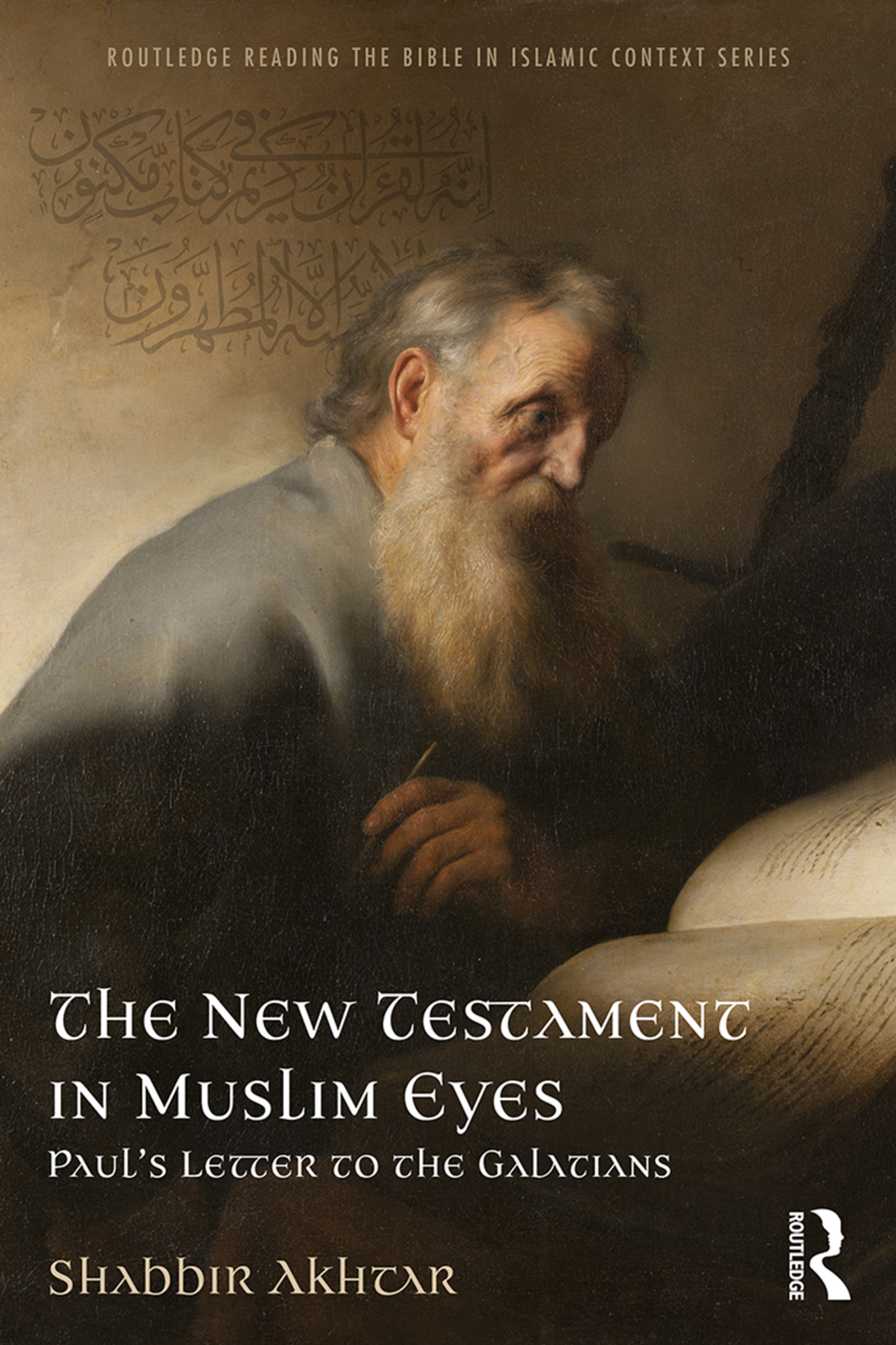
The New Testament in Muslim Eyes This book explores Christian origins by examining a key New Testament epistle, Paul’s letter to the Galatian churches, seen by Christians as the charter of Christian liberty from the inherited Jewish law. The New Testament in Muslim Eyes provides a close textual commentary on perhaps the earliest declaration of Paul’s apostleship and of his undying commitment to the risen Christ. It notes the subtleties of the Greek original against the backdrop of an exciting glimpse of Quranic Arabic parallels and differences. It asks: Does Paul qualify as a prophet of Allah (God)? The thoughts of Paul are assessed by examining his claims against the background of Islam’s rival views of Abraham and his legacy. The Arabic Quran framed and inspired the life of the Arab Apostle, Muhammad, who was sent, according to Islam, to all humanity, Jewish and Gentile alike. Pauline themes are set in dialectical tension with the claims of the Quran. Akhtar compares and contrasts the two rival faiths with regard to: the resources of human nature, the salvation of the sinner, and the status of the works of the law. Both Christians and Muslims concur on the need for God’s grace, an essential condition of success in the life of faith. The core Pauline Christian doctrine of justification by faith alone is scrutinised and assessed from a variety of non-Christian, especially Islamic, stances. Providing an Islamic view of Christian origins, this book helps to build bridges between the two religions. It will be a valuable resource to students and scholars of Biblical Studies, Islamic Studies, and the Philosophy of Religion. POLITICAL SCIENCE,World,Middle Eastern

A Concise History of the Middle East A Concise History of the Middle East provides a comprehensive introduction to the history of this turbulent region. Spanning from pre-Islam to the present day, it explores the evolution of Islamic institutions and culture, the influence of the West, modernization efforts in the Middle East, the struggle of various peoples for political independence, the Arab–Israel conflict, the reassertion of Islamic values and power, the issues surrounding the Palestinian Question, and the Middle East post-9/11 and post-Arab uprisings. The twelfth edition has been fully revised to reflect the most recent events in, and concerns of, the region, including the presence of ISIS and other non-state actors, the civil wars in Syria and Yemen, and the refugee crisis. New parts and part timelines will help students grasp and contextualize the long and complicated history of the region. With updated biographical sketches and glossary, and a new concluding chapter, this book remains the quintessential text for students of Middle East history. POLITICAL SCIENCE,World,Middle Eastern

Soldiering Under Occupation Often, violent behavior or harassment from a soldier is dismissed by the military as unacceptable acts by individuals termed, “rotten apples.†In this study, the author argues that this dismissal is unsatisfactory and that there is an urgent need to look at the (mis)behavior of soldiers from a structural point of view. When soldiers serve as an occupational force, they find themselves in a particular situation influenced by structural circumstances that heavily influence their behavior and moral decision-making. This study focuses on young Israeli men and their experiences as combat soldiers in the Israeli Defense Forces (IDF), particularly those who served in the “Occupied Palestinian Territories†(OPT) during the “Al Aqsa Intifada,†which broke out in 2000. In describing the soldiers’ circumstances, especially focusing on space, the study shows how processes of numbing on different levels influence the (moral) behavior of these soldiers. POLITICAL SCIENCE,World,Middle Eastern

Mastering Soldiers Studies of the military that deal with the actual experience of troops in the field are still rare in the social sciences. In fact, this ethnographic study of an elite unit in the Israeli Defense Force is the only one of its kind. As an officer of this unit and a professional anthropologist, the author was ideally positioned for his role as participant observer. During the eight years he spent with his unit he focused primarily on such notions as "conflict", "the enemy", and "soldiering" because they are, he argues, the key points of reference for "what we are" and "what we are trying to do" and form the basis for interpreting the environment within which armies operate. Relying on the latest anthropological approaches to cognitive models and the social constructions of emotion and masculinity, the author offers an in-depth analysis of the dynamics that drive the men's attitudes and behavior, and a rare and fascinating insight into the reality of military life. POLITICAL SCIENCE,World,Middle Eastern
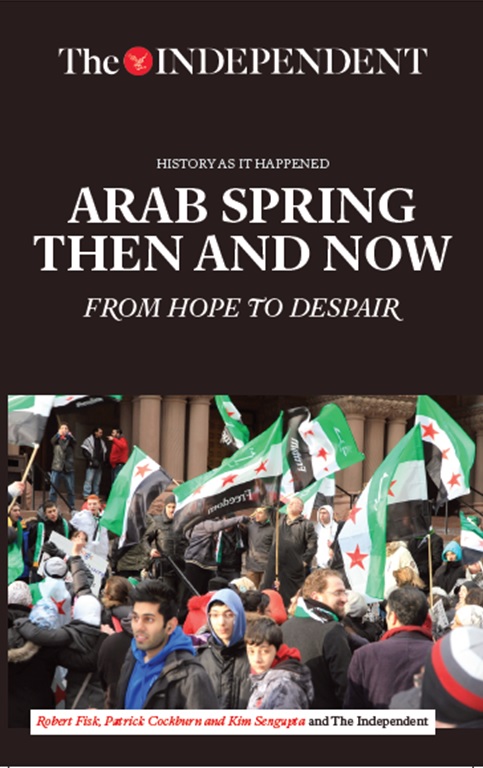
Arab Spring Then and Now Middle East conflict and the Arab Spring:Gain insight and learn from two of the most acclaimed experts on the Middle East ----------In December 2010, the “Tunisian Revolution†touched off a wave of protests, riots, revolutions and civil wars throughout the Middle East. Initially the world hoped for positive change – democracy, free elections, and human rights. But, by 2012 the Arab Spring had morphed into “Arab Winter†bringing death, destruction, and despair. The Independent’s Robert Fisk and Patrick Cockburn, two of the most acclaimed Middle East correspondents of our generation, examine the events of this regional tsunami that threatens to have an impact on our world for years to come. POLITICAL SCIENCE,World,Middle Eastern

The Future of the Middle East This deeply informed book considers the intertwined roles of faith, force, and finance in shaping the modern Middle East, including the relentless surge of terror in the region and beyond. Monte Palmer provides lessons learned from ten critical periods, beginning with World War I through the current chaos and stalemate. POLITICAL SCIENCE,World,Middle Eastern

Kings and Presidents An insider's account of the often-fraught U.S.-Saudi relationship Saudi Arabia and the United States have been partners since 1943, when President Roosevelt met with two future Saudi monarchs. Subsequent U.S. presidents have had direct relationships with those kings and their successorssetting the tone for a special partnership between an absolute monarchy with a unique Islamic identity and the world's most powerful democracy. Although based in large part on economic interests, the U.S.-Saudi relationship has rarely been smooth. Differences over Israel have caused friction since the early days, and ambiguities about Saudi involvementor lack of itin the September 11 terrorist attacks against the United States continue to haunt the relationship. Now, both countries have new, still-to be-tested leaders in President Trump and King Salman. Bruce Riedel for decades has followed these kings and presidents during his career at the CIA, the White House, and Brookings. This book offers an insider's account of the U.S.-Saudi relationship, with unique insights. Using declassified documents, memoirs by both Saudis and Americans, and eyewitness accounts, this book takes the reader inside the royal palaces, the holy cities, and the White House to gain an understanding of this complex partnership. POLITICAL SCIENCE,World,Middle Eastern

The War of Return Two prominent Israeli liberals argue that for the conflict between Israel and the Palestinians to end with peace, Palestinians must come to terms with the fact that there will be no "right of return." In 1948, seven hundred thousand Palestinians were forced out of their homes by the first Arab-Israeli War. More than seventy years later, most of their houses are long gone, but millions of their descendants are still registered as refugees, with many living in refugee camps. This group—unlike countless others that were displaced in the aftermath of World War II and other conflicts—has remained unsettled, demanding to settle in the state of Israel. Their belief in a "right of return" is one of the largest obstacles to successful diplomacy and lasting peace in the region. In The War of Return, Adi Schwartz and Einat Wilf—both liberal Israelis supportive of a two-state solution—reveal the origins of the idea of a right of return, and explain how UNRWA - the very agency charged with finding a solution for the refugees - gave in to Palestinian, Arab and international political pressure to create a permanent “refugee†problem. They argue that this Palestinian demand for a “right of return†has no legal or moral basis and make an impassioned plea for the US, the UN, and the EU to recognize this fact, for the good of Israelis and Palestinians alike. A runaway bestseller in Israel, the first English translation of The War of Return is certain to spark lively debate throughout America and abroad. POLITICAL SCIENCE,World,Middle Eastern
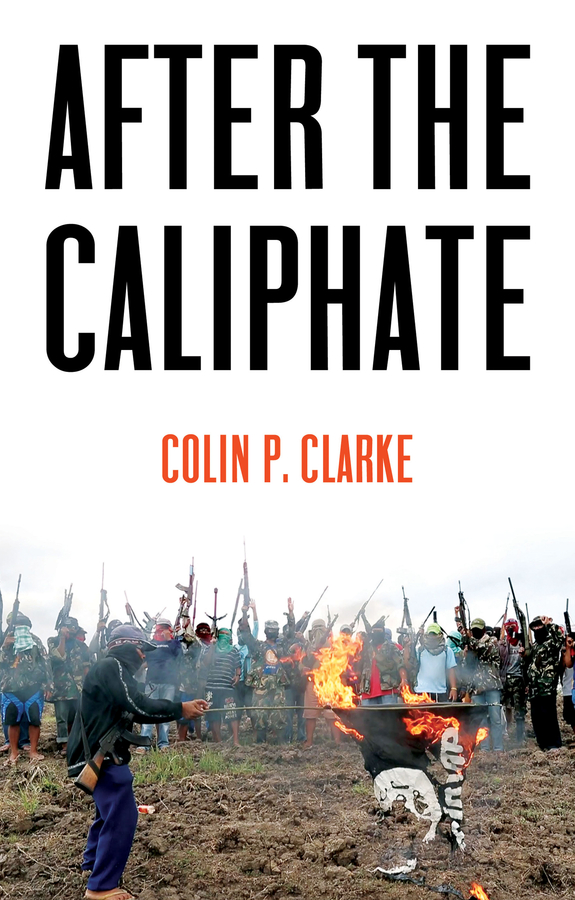
After the Caliphate In 2014, the declaration of the Islamic State caliphate was hailed as a major victory by the global jihadist movement. But it was short-lived. Three years on, the caliphate was destroyed, leaving its surviving fighters – many of whom were foreign recruits – to retreat and scatter across the globe. So what happens now? Is this the beginning of the end of IS? Or can it adapt and regroup after the physical fall of the caliphate? In this timely analysis, terrorism expert Colin P. Clarke takes stock of IS – its roots, its evolution, and its monumental setbacks – to assess the road ahead. The caliphate, he argues, was an anomaly. The future of the global jihadist movement will look very much like its past – with peripatetic and divided groups of militants dispersing to new battlefields, from North Africa to Southeast Asia, where they will join existing civil wars, establish safe havens and sanctuaries, and seek ways of conducting spectacular attacks in the West that inspire new followers. In this fragmented and atomized form, Clarke cautions, IS could become even more dangerous and challenging for counterterrorism forces, as its splinter groups threaten renewed and heightened violence across the globe. POLITICAL SCIENCE,World,Middle Eastern

An Army Like No Other A history of the IDF that argues that Israel is a nation formed by its army. The Israeli army, officially named the Israel Defence Forces (IDF), was established in 1948 by David Ben-Gurion, Israel's first prime minister, who believed that 'the whole nation is the army'. In his mind, the IDF was to be an army like no other. It was the instrument that might transform a diverse population into a new people. Since the foundation of Israel, therefore, the IDF has been the largest, richest and most influential institution in Israel's Jewish society and is the nursery of its social, economic and political ruling class. In this fascinating history, Bresheeth charts the evolution of the IDF from the Nakba to the continued assaults upon Gaza, and shows that the state of Israel has been formed out of its wars. He also gives an account of his own experiences as a young conscript during the 1967 war. He argues that the army is embedded in all aspects of daily life and identity. And that we should not merely see it as a fighting force enjoying an international reputation, but as the central ideological, political and financial institution of Israeli society. As a consequence, we have to reconsider our assumptions on what any kind of peace might look like. POLITICAL SCIENCE,World,Middle Eastern

Sinews of War and Trade A wide-ranging account of shipping and capitalism in the Middle East On the map of global trade, China is now the factory of the world. A parade of ships full of raw commodities -iron ore, coal, oil- arrive in its ports, and fleets of container ships leave with manufactured goods in all directions. The oil that fuels China's manufacturing comes primarily from the Arabian Peninsula. Much of the material shipped from China are transported through the ports of Arabian Peninsula, Dubai's Jabal Ali port foremost among them. China's 'maritime silk road' flanks the Peninsula on all sides. Sinews of War and Trade is the story of what the making of new ports and shipping infrastructures has meant not only for the Arabian Peninsula itself, but for the region and the world beyond. The book is the account of how maritime transportation is not simply an enabling adjunct of trade, but central to the very fabric of global capitalism. The ports that serve maritime trade, logistics, and hydrocarbon transport create racialised hierarchies of labour, engineer the lived environment, aid the accumulation of capital regionally and globally, and carry forward colonial regimes of profit, law and administration. POLITICAL SCIENCE,World,Middle Eastern

MBS A gripping, behind-the-scenes portrait of the rise of Saudi Arabia’s secretive and mercurial new ruler “Revelatory . . . a vivid portrait of how MBS has altered the kingdom during his half-decade of rule.”—The Washington Post MBS is the untold story of how a mysterious young prince emerged from Saudi Arabia’s sprawling royal family to overhaul the economy and society of the richest country in the Middle East—and gather as much power as possible into his own hands. Since his father, King Salman, ascended to the throne in 2015, Mohammed bin Salman has leveraged his influence to restructure the kingdom’s economy, loosen its strict Islamic social codes, and confront its enemies around the region, especially Iran. That vision won him fans at home and on Wall Street, in Silicon Valley, in Hollywood, and at the White House, where President Trump embraced the prince as a key player in his own vision for the Middle East. But over time, the sheen of the visionary young reformer has become tarnished, leaving many struggling to determine whether MBS is in fact a rising dictator whose inexperience and rash decisions are destabilizing the world’s most volatile region. Based on years of reporting and hundreds of interviews, MBS reveals the machinations behind the kingdom’s catastrophic military intervention in Yemen, the bizarre detention of princes and businessmen in the Riyadh Ritz-Carlton, and the shifting Saudi relationships with Israel and the United States. And finally, it sheds new light on the greatest scandal of the young autocrat’s rise: the brutal killing of journalist Jamal Khashoggi by Saudi agents in Istanbul, a crime that shook Saudi Arabia’s relationship with Washington and left the world wondering whether MBS could get away with murder. MBS is a riveting, eye-opening account of how the young prince has wielded vast powers to reshape his kingdom and the world around him. POLITICAL SCIENCE,World,Middle Eastern

The Middle East In the more succinct Fifteenth Edition of The Middle East, editor Ellen Lust brings important new coverage to this comprehensive, balanced, and superbly researched text. In clear prose, Lust and her contributors explain the many complex changes taking place across the region. All country profile chapters now address domestic and regional conflict more explicitly and all tables, figures, boxes, and maps have been fully updated with the most recent data and information. This best-selling text not only helps you comprehend more fully the world around you, but it also enables you to recognize and formulate policies that can more successfully engage the Middle East. POLITICAL SCIENCE,World,Middle Eastern
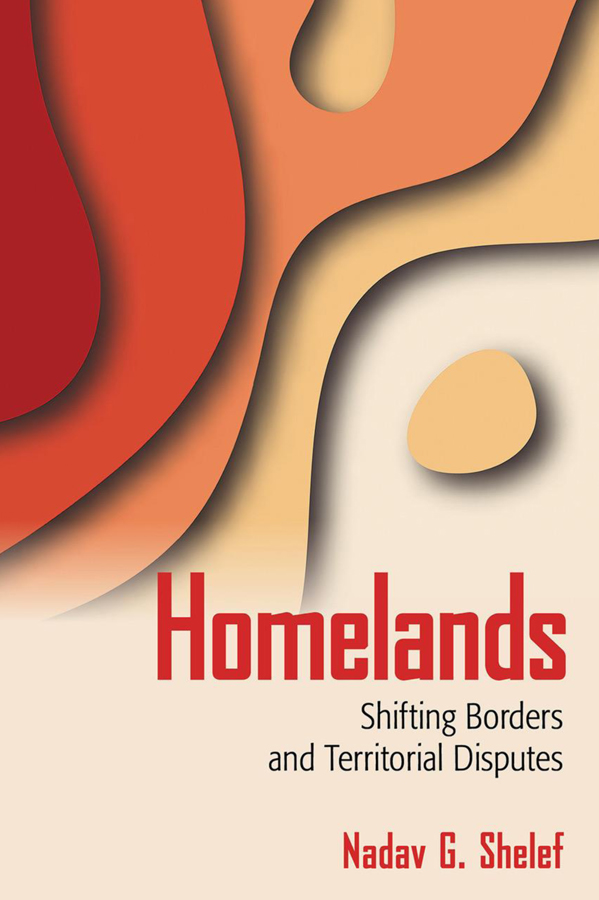
Homelands Why are some territorial partitions accepted as the appropriate borders of a nation's homeland, whereas in other places conflict continues despite or even because of division of territory? In Homelands, Nadav G. Shelef develops a theory of what homelands are that acknowledges both their importance in domestic and international politics and their change over time. These changes, he argues, driven by domestic political competition and help explain the variation in whether partitions resolve conflict. Homelands also provides systematic, comparable data about the homeland status of lost territory over time that allow it to bridge the persistent gap between constructivist theories of nationalism and positivist empirical analyses of international relations. POLITICAL SCIENCE,World,Middle Eastern

The Return of the Past The Return of the Past analyzes the impact and historical antecedents of the Arab Spring, providing a window into the evolving politics of the region and the socio-political forces that brought about the protests and led to change and civil war. POLITICAL SCIENCE,World,Middle Eastern

War in the Age of Trump Is the fall of ISIS the end of the perpetual war in the Middle East? In this urgent and timely book, Patrick Cockburn writes the first draft of the history of the current crisis in the Middle East. Here he charts the period from the recapture of Mosul in 2017 to Turkey’s attack on Kurdish territory in November 2019, and recounts the new phase in the wars of disintegration that have plagued the region. The ground battle with the caliphate is perhaps over, but was this the end of the conflict that has scarred these nations for decades? Cockburn offers panoramic on-the-ground analysis as well as a lifetime’s study of the region. And here he shows how peace appears a distant possibility with the continuation of conflict in Syria, Saudi Arabia’s violent intervention in the Yemen, riots in Baghdad and Tehran. At the same time, the rising aggression between Israel and Iran, the raising of stakes between the US, Russia and Turkey, shows that this remains the theatre of the proxy wars of the world’s superpowers. Has Trump abandoned the area for good, leaving a vacuum for others—Putin, Erdogan, Mohammed Bin Saud—to fill? He also looks at what might happen to the Islamic State: will it disappear now that it has lost its territory or emerge in a new form and with renewed violence? POLITICAL SCIENCE,World,Middle Eastern

Losing the Long Game The definitive account of how regime change in the Middle East has proven so tempting to American policymakers for decades—and why it always seems to go wrong. "Must reading—by someone who saw it first-hand—for all interested in America’s foreign policy and its place in the world.â€â€”Robin Wright Since the end of World War II, the United States has set out to oust governments in the Middle East on an average of once per decade—in places as diverse as Iran, Iraq, Afghanistan (twice), Egypt, Libya, and Syria. The reasons for these interventions have also been extremely diverse, and the methods by which the United States pursued regime change have likewise been highly varied, ranging from diplomatic pressure alone to outright military invasion and occupation. What is common to all the operations, however, is that they failed to achieve their ultimate goals, produced a range of unintended and even catastrophic consequences, carried heavy financial and human costs, and in many cases left the countries in question worse off than they were before. Philip H. Gordon's Losing the Long Game is a thorough and riveting look at the U.S. experience with regime change over the past seventy years, and an insider’s view on U.S. policymaking in the region at the highest levels. It is the story of repeated U.S. interventions in the region that always started out with high hopes and often the best of intentions, but never turned out well. No future discussion of U.S. policy in the Middle East will be complete without taking into account the lessons of the past, especially at a time of intense domestic polarization and reckoning with America's standing in world. POLITICAL SCIENCE,World,Middle Eastern

When the Bulbul Stopped Singing The Israeli army invaded Ramallah in March 2002. A tank stood at the end of Raja Shehadeh’s road; Israeli soldiers patrolled from the rooftops. Four soldiers took over his brother’s apartment and then used him as a human shield as they went through the building, while his wife tried to keep her composure for the sake of their frightened children, ages four and six. This book is an account of what it is like to be under siege: the terror, the frustrations, the humiliations, and the rage of civilians becoming trapped in their own homes and at the mercy of young soldiers who have been ordered to set aside their own sense of human decency in order to bully, harass and in some cases brutalize an unarmed population. How do you pass your time when you are imprisoned in your own home? What do you do when you cannot cross the neighborhood to help your sick mother? And what does it feel like when occupier and occupied, who are supposed to be enemies, are forced to set aside feelings of empathy? When the Bulbul Stopped Singing reveals universal and timeless truths. A new introduction by Colum McCann and an afterword by the author show how little things have changed since this record of life under siege was first compiled. POLITICAL SCIENCE,World,Middle Eastern
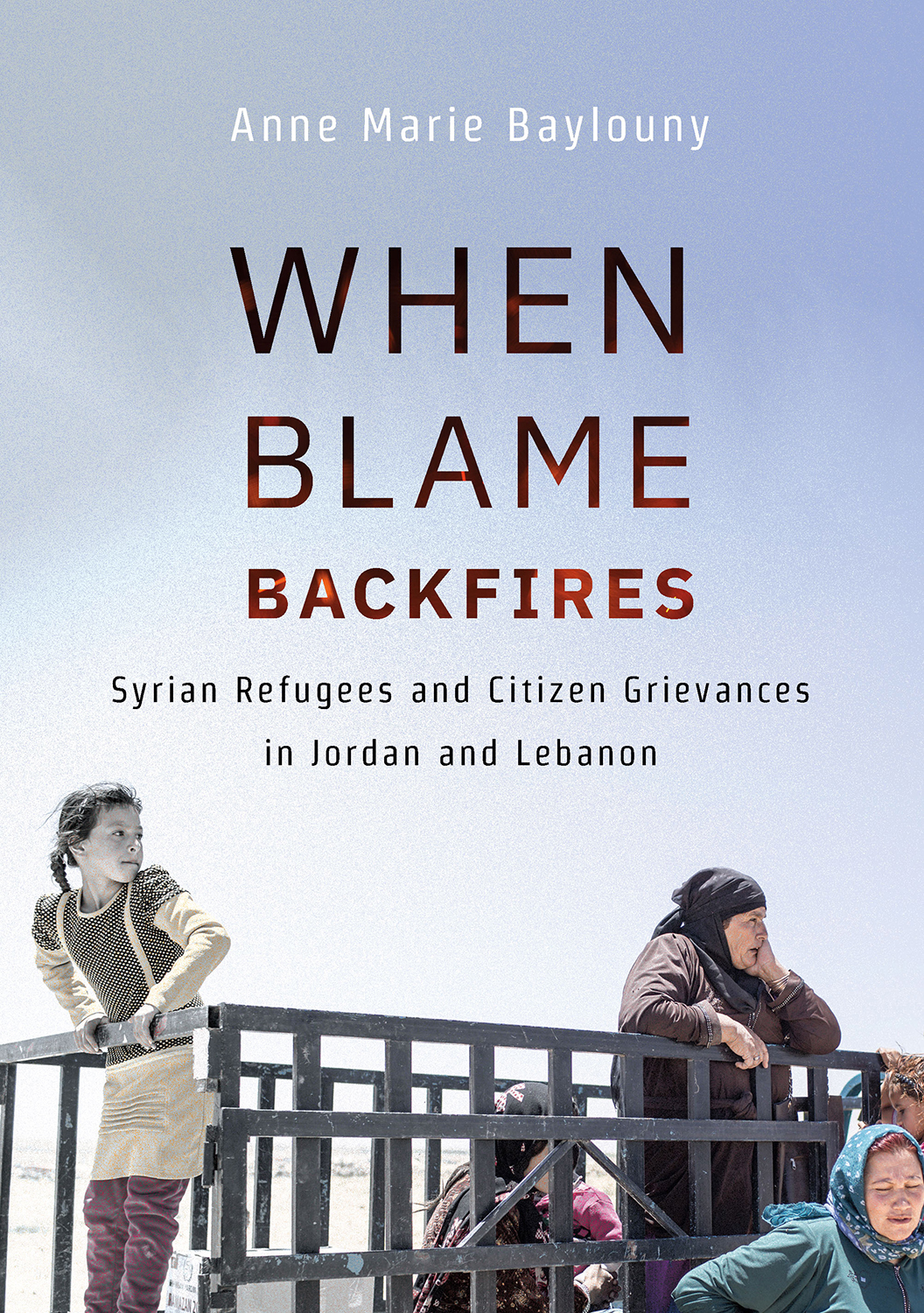
When Blame Backfires The recent influx of Syrian refugees into Jordan and Lebanon has stimulated domestic political action against these countries' governments. This is the dramatic argument at the heart of Anne Marie Baylouny's When Blame Backfires. Baylouny examines the effects on Jordan and Lebanon of hosting huge numbers of Syrian refugees. How has the populace reacted to the real and perceived negative effects of the refugees? In thought-provoking analysis, Baylouny shows how the demographic changes that result from mass immigration put stress on existing problems in these two countries, worsening them to the point of affecting daily lives. One might expect that, as a result, refugees and minorities would become the focus of citizen anger. But as When Blame Backfires demonstrates, this is not always the case. What Baylouny exposes, instead, is that many of the problems that might be associated with refugees are in fact endemic to the normal routine of citizens' lives. The refugee crisis exacerbated an already dire situation rather than created it, and Jordanians and Lebanese started to protest not only against the presence of refugees but against the incompetence and corruption of their own governments as well. From small-scale protests about goods and public services, citizens progressed to organized and formal national movements calling for economic change and rights to public services not previously provided. This dramatic shift in protest and political discontent was, Baylouny shows, the direct result of the arrival of Syrian refugees. POLITICAL SCIENCE,World,Middle Eastern

Contemporary Domestic and Foreign Policies of Iran This book is a comprehensive analysis of the domestic and foreign politics of Iran, focusing on its complex nature from political, social and cultural perspectives. It has adopted a multidisciplinary approach, combining comparative politics and intellectual and modern history with international relations. It analyses the institutional structure of the Islamic Republic, the main political and social actors and alliances, as well as Iranian opposition forces both inside and outside the country. The book tries to simplify the seemingly intractable complexity of the Islamic Republic by demystifying it and using political science methods to prove that it is a peculiar hybrid regime. POLITICAL SCIENCE,World,Middle Eastern
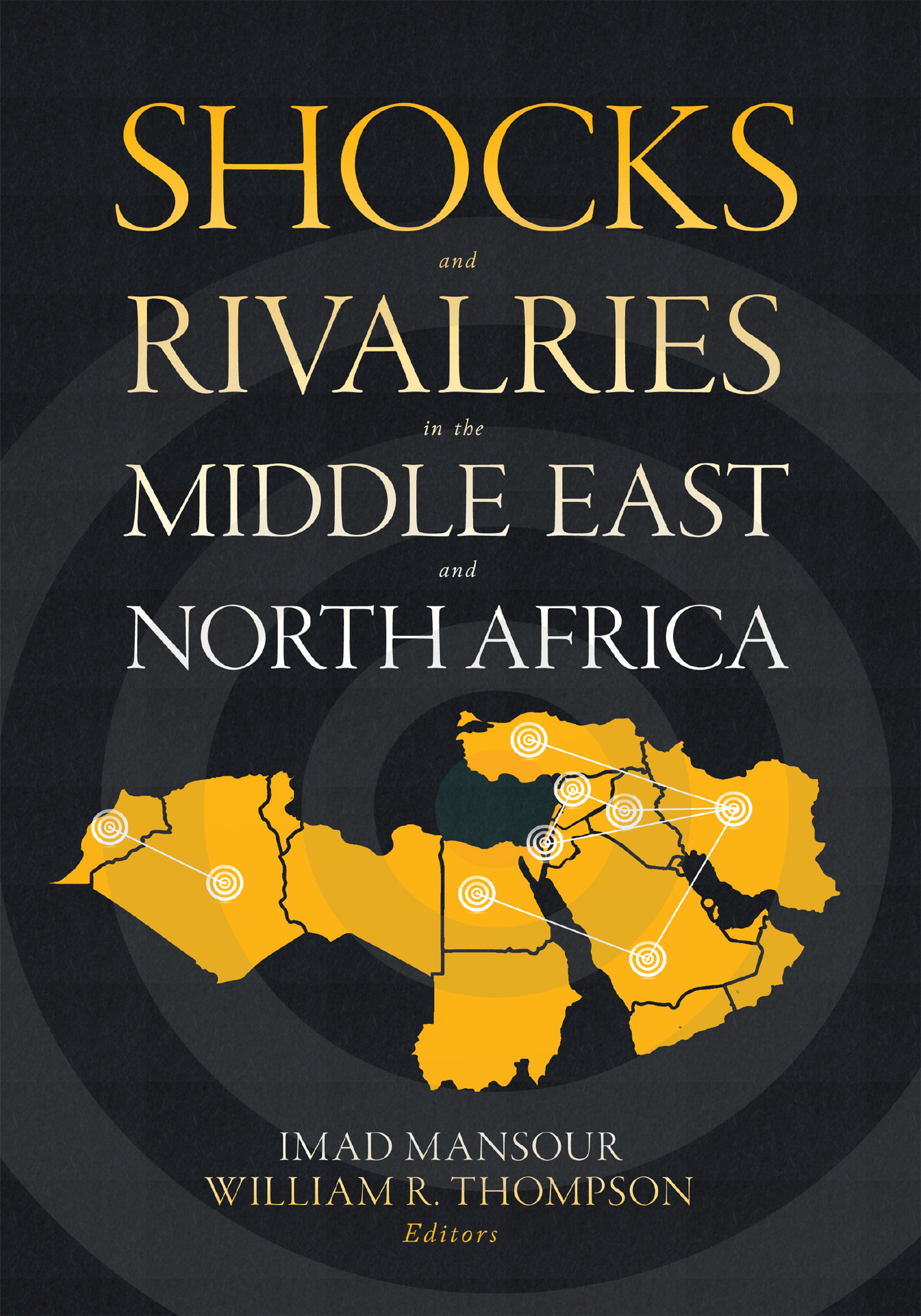
Shocks and Rivalries in the Middle East and North Africa Shocks and Rivalries in the Middle East and North Africa is the first book to examine issue-driven antagonisms within groups of MENA states and their impact on relations within the region. The volume also considers how shock events can alter interstate tensions and the trajectory of conflict. POLITICAL SCIENCE,World,Middle Eastern

Birth-Throes of the Israeli Homeland The book brings forth various perspectives on the Israeli "homeland" (moledet) from various known Israeli intellectuals such as Boaz Evron, Menachem Brinker, Jacqueline Kahanoff and more. Binding together various academic fields to deal with the question of the essence of the Israeli homeland: from the examination of the status of the Israeli homeland by such known sociologist as Michael Feige, to the historical analysis of Robert Wistrich of the place Israel occupies in history in relation to historical antisemitism. The study also examines various movements that bear significant importance on the development of the notion of the Israeli homeland in Israeli society: Such movement as "The New Hebrews" and Hebrewism are examined both historically in relation to their place in Zionist history and ideologically in comparison with other prominent movements. Drawing on the work of Jacqueline Kahanoff to provide a unique Mediterranean model for the Israeli homeland, the volume examines prominent models among the Religious Zionist sector of Israeli society regarding the relation of the biblical homeland to the actual homeland of our times. Discussing the various interpretations of the concept of the nation and its land in the discourse of Hebrew and Israeli identity, the book is a key resource for scholars interested in nationalism, philosophy, modern Jewish history and Israeli Studies. POLITICAL SCIENCE,World,Middle Eastern
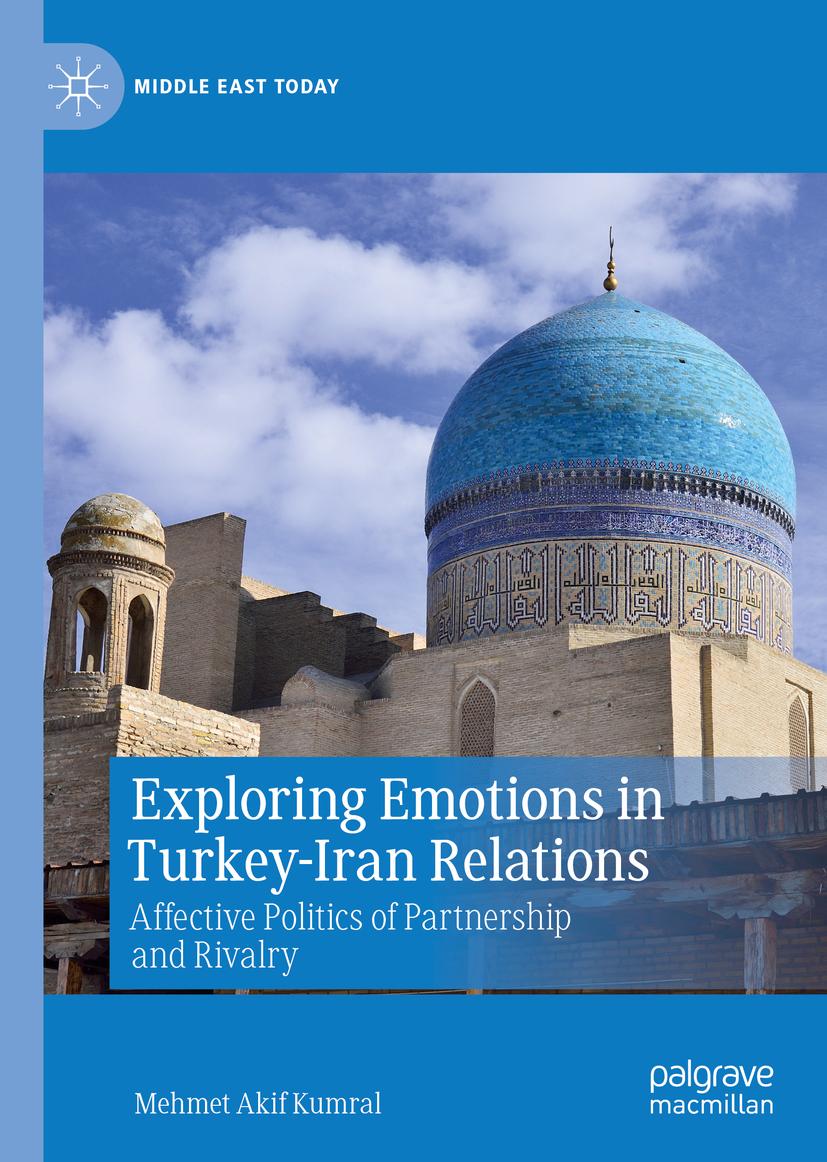
Exploring Emotions in Turkey-Iran Relations This book explores emotional-affective implications of partnership and rivalry in Turkey-Iran relations. The main proposition of this research underlines the theoretical need to reconnect psycho-social conceptualizations of “emotionality,†“affectivity,†“normativity,†and “relationality.†By combining key theoretical findings, the book offers a holistic conceptual framework to better analyze emotional-affective configuration of relational rules and roles in trans-governmental neighborhood interactions. The empirical chapters look at four consecutive periods extending from the end of First World War (November 1918) to the resuscitation of US sanctions against Iran (November 2018). In each episode, global-regional contours and dyadic dynamics of Ankara-Tehran relationship are examined critically. The century-long history of emotional entanglements and affective arrangements exposes complex patterning of “feeling rules.†Two countervailing constellations still reign over relational narratives. While the 1514 Çaldıran war myth reproduces sectarian resentment and confrontational climate, the 1639 Kasr-ı Şirin peace story reconstructs secular sympathy and collaborative atmosphere in Turkish-Iranian affairs. POLITICAL SCIENCE,World,Middle Eastern
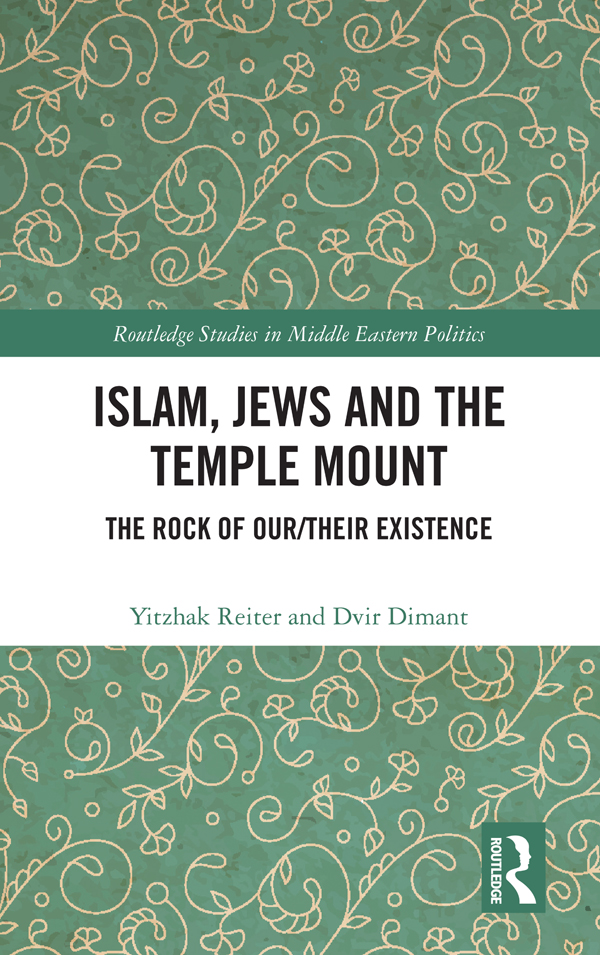
Islam, Jews and the Temple Mount This study presents the first comprehensive survey of the abundant early Islamic sources that recognize the historical Jewish bond to the Temple Mount (Masjid al-Aqsa) and Jerusalem. Analyzing these sources in light of the views of contemporary Muslim religious scholars, thinkers and writers, who – in the context of the Arab-Israeli conflict – deny any Jewish ties to the Temple Mount and promote the argument that no Jewish Temple ever stood on the Temple Mount. The book describes how this process of denying Jewish ties to the site has become the cultural rationale for UNESCO decisions in recent years regarding holy sites in Jerusalem, Bethlehem and Hebron, which use Muslim Arabic terminology and overlook the Jewish (and Christian) history and sanctification of these sites. Denying the Jewish ties to the Temple Mount for political purposes inadvertently undermines the legitimacy of Islam’s sanctification of Al-Aqsa and the Dome of the Rock as well as the credibility of the most important sources in Arabic, which constitute the classics of Islam and provide the foundation for its culture and identity. Identifying and presenting the Jewish sources in the Bible, Babylonian Talmud and exegesis on which these Islamic traditions are based, this volume is a key resource for readers interested in Islam, Judaism, religion and political science and history in the Middle East. POLITICAL SCIENCE,World,Middle Eastern
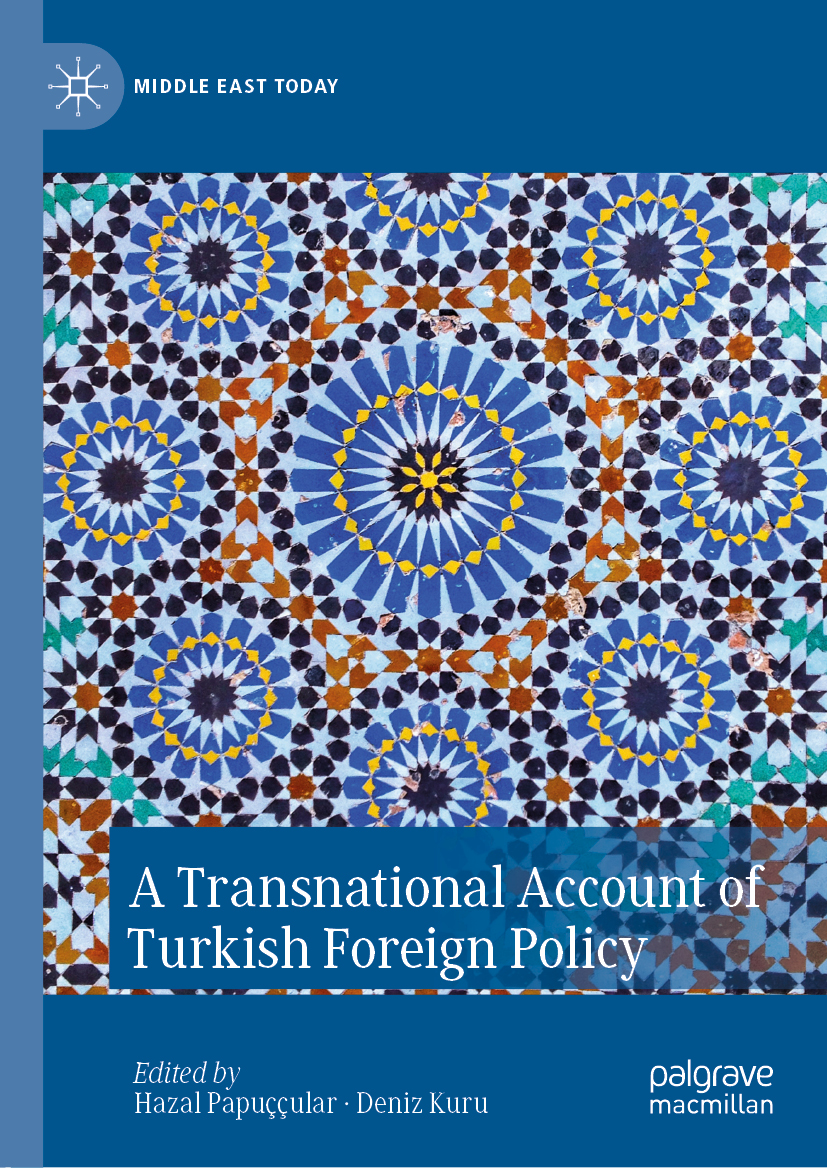
A Transnational Account of Turkish Foreign Policy This book offers an analysis of Turkish foreign policy based on transnational(ist) perspectives. In order to counterbalance the state-centric accounts that dominate this area of study, the authors provide theoretical frameworks as well as historical and contemporary case studies that emphasize transnational dynamics. The content is divided into four complementary sections that explain and exemplify transnational (f)actors in the context of Turkish foreign policy. The first addresses theoretical and ideational frameworks that illustrate the relevance of a transnational account, while the second demonstrates the possibility of developing transnationally oriented approaches even in historical cases, going beyond a presentist focus. In the third and fourth sections, the book focuses on two prominent non-state actors, namely diaspora communities and non-governmental organizations, which operate at the interstices of the domestic and the international. This allows the authors to highlight the significance of transnational dynamics in Turkey’s foreign policy. POLITICAL SCIENCE,World,Middle Eastern

The Wall Between Us “The biology of Israel/Palestine simply and beautifully revealed,†from the author of Down and Out Today: Notes from the Gutter (Jon Snow, journalist and presenter). Writer Matthew Small traveled to the Holy Land to further his understanding of the enduring conflict between Israel and Palestine. While there, he discovered beauty, fear and suffering like nowhere else in the world. In these honest and evocative reflections, Small retells his experiences of crossing into the West Bank to work the olive harvest with Palestinian farmers. He relates his encounters with organizations that are determinedly working to sow the seeds of peace in soils that are deeply scarred by suffering and war. While reliving these unforgettable experiences, through his writing he struggles to find why the wall between these two groups of people exists. Deciding to join a group of international and Israeli volunteers, Small attempts to show that, despite the ongoing occupation, peace is not lost, but still to be discovered. “Matthew Small, despite the horror of both the war, and the wall, works and travels both sides of the divide, and brings us to an understanding of where the seeds of peace can yet be found.â€â€”Jon Snow, journalist and presenter “What is really refreshing about this book is the way Small writes from a very personal perspective, often admitting in his diary entries that he’s unsure what to write or how he feels about the situation. His emotion surrounding his visit and the people living amongst the occupation every day is portrayed in a gritty, raw way.â€â€”The Bookbag POLITICAL SCIENCE,World,Middle Eastern

Modern Saudi Arabia The Kingdom of Saudi Arabia, known for its petroleum reserves and leadership role in the Middle East, is explored in this latest addition to the Understanding Modern Nations series. Organized into thematic chapters, Modern Saudi Arabia covers both history and contemporary daily life. Chapter topics include: Geography; History; Government and Politics; Economy; Religion and Thought; Social Classes and Ethnicity; Gender, Marriage, and Sexuality; Education; Language; Etiquette; Literature and Drama; Art and Architecture; Music and Dance; Food; Leisure and Sports; and Media and Popular Culture. Each chapter contains an overview of the topic and alphabetized entries on examples of each theme. A detailed historical timelinespans from prehistoric times to the present. Special appendices are also included, offering profiles of a typical day in the life of representative members of Saudi society, a glossary, key facts and figures about Saudi Arabia, and a holiday chart. This volume will be useful for readers looking for specific topical information and for those who want to read entire chapters to gain a deeper perspective on aspects of modern Saudi Arabia. POLITICAL SCIENCE,World,Middle Eastern
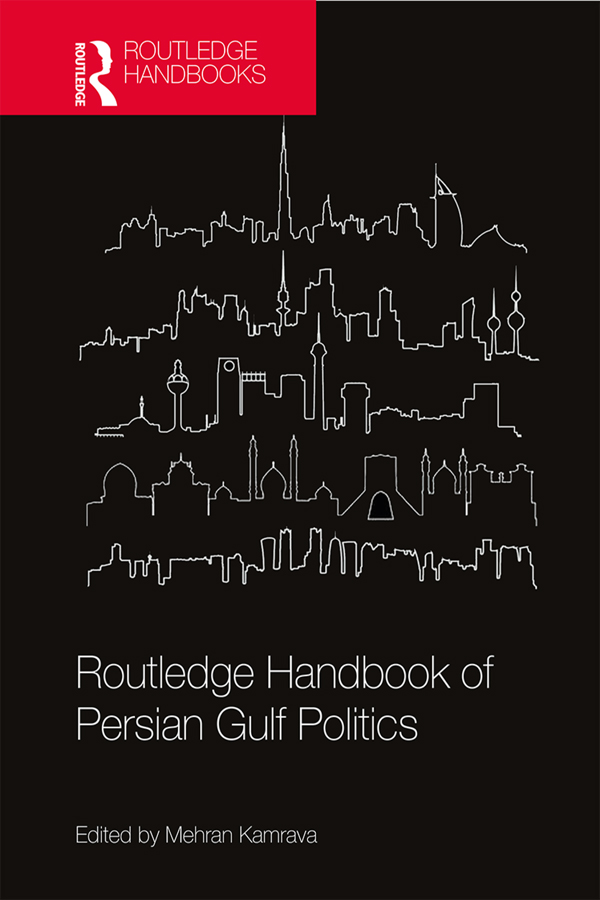
Routledge Handbook of Persian Gulf Politics The Routledge Handbook of Persian Gulf Politics provides a comprehensive and up-to-date analysis of Persian Gulf politics, history, economics, and society. The volume begins its examination of Ottoman rule in the Arabian Peninsula, exploring other dimensions of the region’s history up until and after independence in the 1960s and 1970s. Featuring scholars from a range of disciplines, the book demonstrates how the Persian Gulf’s current, complex politics is a product of interwoven dynamics rooted in historical developments and memories, profound social, cultural, and economic changes underway since the 1980s and the 1990s, and inter-state and international relations among both regional actors and between them and the rest of the world. The book comprises a total of 36 individual chapters divided into the following six sections: Historical Context Society and Culture Economic Development Domestic Politics Regional Security Dynamics The Persian Gulf and the World Examining the Persian Gulf’s increasing importance in regional politics, diplomacy, economics, and security issues, the volume is a valuable resource for scholars, students, and policy makers interested in political science, history, Gulf studies, and the Middle East. POLITICAL SCIENCE,World,Middle Eastern

Making Sense of Muslim Fundamentalisms Studying Muslim fundamentalisms, this book compares key movements, examining their commonalities, differences, and intricate relations, as well as their achievements and failures. Muslim fundamentalisms have the sympathy of approximately half of the Muslim population in the world. Yet, they are divided among themselves and are in a constant state of controversy. The research dwells on the leading fundamentalist movements, such as the Muslim Brothers, Tablighi-Jamaʻat, al-Qaeda, and ISIS, and illustrates how differently they think about the West and its culture, democracy, and women’s presence in the public sphere. By identifying these trends, and studying them comparatively, the book enables the interested reader to make sense of the plethora of fundamentalist movements, which are otherwise lumped together by the media and are barely discernible for the reader. Whereas most studies of Muslim fundamentalism focus on organizational or militant actions that the movements perform, this study concentrates on their efforts to Islamize society through everyday life in a peaceful manner. Identifying the different strands of Muslim fundamentalisms, the book will be a key resource to a wide range of readers including researchers and students interested in politics, religious, Islamic and Middle Eastern Studies. POLITICAL SCIENCE,World,Middle Eastern
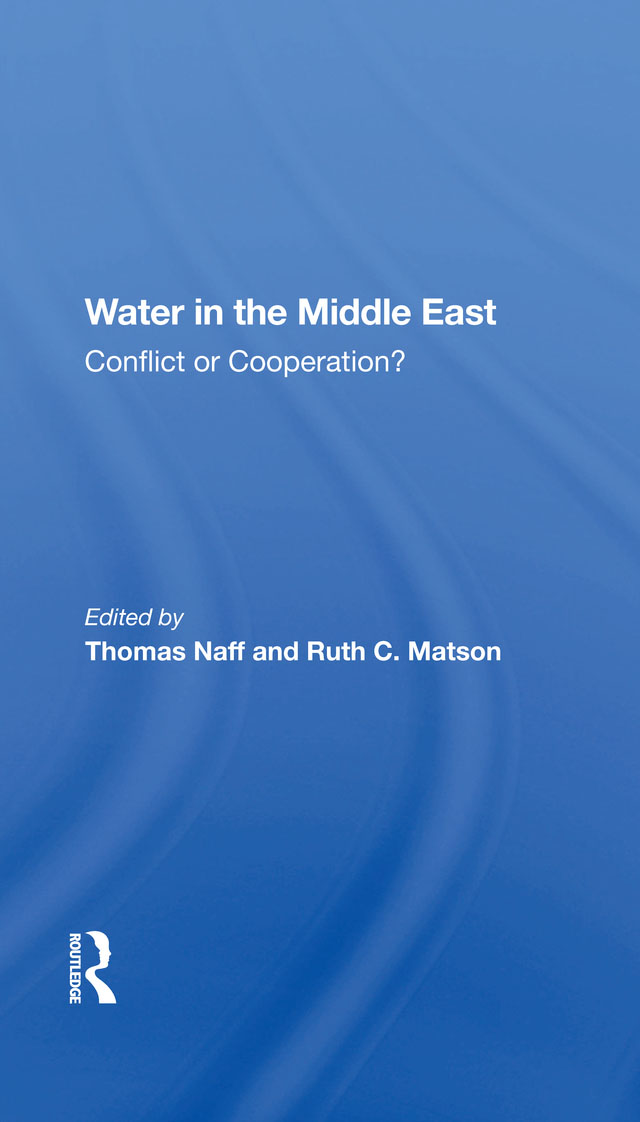
Water In The Middle East The scarcity and rapid depletion of water in one of the world's driest regions continues to be a major determinant of the domestic and external policies of the major actors in the Middle East. Israel, Jordan, and the West Bank will have exhausted virtually all their renewable sources of fresh water by 1995 if current patterns of consumption are not radically altered. This study examines the hydrological, historical, legal, and strategic dimensions of water problems in the Middle East and discusses their implications for the future. POLITICAL SCIENCE,World,Middle Eastern

Global Jihad in Muslim and non-Muslim Contexts This book examines ten reasons for global jihad today. Specifically, the reasons are (1) radicalization, (2) group dynamics and socialization, (3) social alienation, (4) religious motivations, (5) legal motivations, (6) political motivations, (7) a Clash of Civilizations, (8) economic conditions, (9) transformative learning, and (10) outbidding and internal rifts. To investigate these points, all chapters include the historical background, specific case studies (both past and current), statistics, and theoretical approaches to the subject of global jihad. The main purpose of jihad is to achieve global domination—through any means, including violence—and establish the Caliphate. The Caliphate is a Muslim system of world government that seeks to establish a new world order by overthrowing the current order, effectively creating an all-encompassing Islamic state. POLITICAL SCIENCE,World,Middle Eastern

Iraq since the Invasion This book addresses the complex events and unexpected outcomes of military intervention by the United States and its allies in Iraq in 2003. Considering the long-term outcomes of the intervention, this volume examines economic collapse, societal disorder, and increased regional conflict in Iraq. The book assesses the means by which American strategists imposed a new political order, generalising corruption, sectarian preference, and ethnic cleansing, and stimulating mass population movements in and from Iraq. Mobilising a multidisciplinary perspective, the book explores the rise and fall of Iraq’s confessional leaders, the emergence of a popular movement for reform, and the demands of young radicals focused upon revolutionary change. The product of years of intensive research by Iraqis and international scholars, Iraq since the Invasion considers how an initiative designed to produce “regime change†favourable to the United States and its allies brought unprecedented influence for Iran—both in Iraq and the wider Gulf region. It analyses events in Kurdistan and the impacts of change on relations between Iraq and its neighbours. The book includes a wealth of detail on political, social, and cultural change, and on the experiences of Iraqis during long years of upheaval. It will be of value to researchers and students interested in international relations, development studies, and Middle East politics. POLITICAL SCIENCE,World,Middle Eastern

Reframing Syrian Refugee Insecurity through a Feminist Lens Capturing the unique dynamics of a Global South-South forced migration case, the book provides a comprehensive understanding of Syrian refugee insecurity in Lebanon. It applies a transnational feminist approach to explore the plight of Syrian women who are often absent from and generally neglected in refugee securitized practices. POLITICAL SCIENCE,World,Middle Eastern

The Syria Dilemma Can we stop the bleeding in Syria without its becoming another Iraq? The United States is on the brink of intervention in Syria, but the effect of any eventual American action is impossible to predict. The Syrian conflict has killed more than 100,000 people and displaced millions, yet most observers warn that the worst is still to come. And the international community cannot agree how respond to this humanitarian catastrophe. World leaders have repeatedly resolved not to let atrocities happen in plain view, but the legacy of the bloody and costly intervention in Iraq has left policymakers with little appetite for more military operations. So we find ourselves in the grip of a double burden: the urge to stop the bleeding in Syria, and the fear that attempting to do so would be Iraq redux. What should be done about the apparently intractable Syrian conflict? This book focuses on the ethical and political dilemmas at the heart of the debate about Syria and the possibility of humanitarian intervention in today's world. The contributors—Syria experts, international relations theorists, human rights activists, and scholars of humanitarian intervention—don't always agree, but together they represent the best political thinking on the issue. The Syria Dilemma includes original pieces from Michael Ignatieff, Mary Kaldor, Radwan Ziadeh, Thomas Pierret, Afra Jalabi, and others. Contributors Asli Bâli, Richard Falk, Tom Farer, Charles Glass, Shadi Hamid, Nader Hashemi, Christopher Hill, Michael Ignatieff, Afra Jalabi, Rafif Jouejati, Mary Kaldor, Marc Lynch, Vali Nasr, Thomas Pierret, Danny Postel, Aziz Rana, Christoph Reuter, Kenneth Roth, Anne-Marie Slaughter, Fareed Zakaria, Radwan Ziadeh, Stephen Zunes POLITICAL SCIENCE,World,Middle Eastern
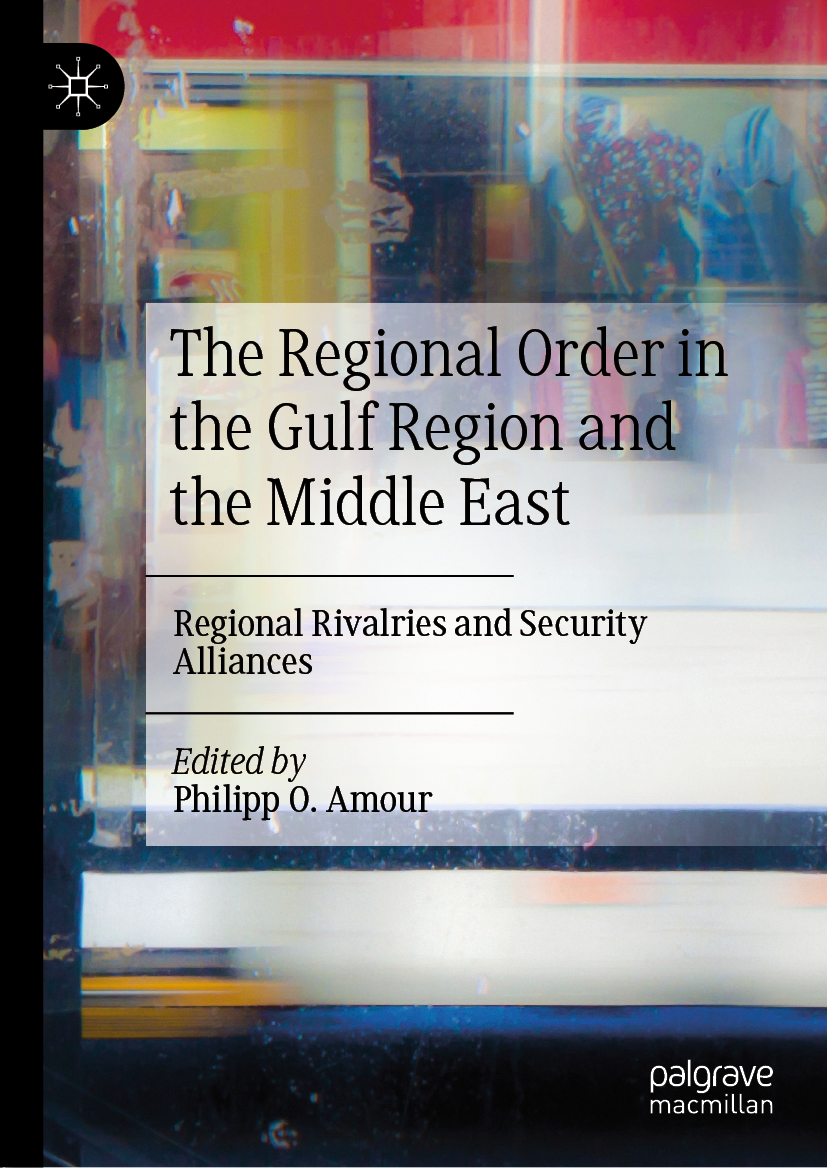
The Regional Order in the Gulf Region and the Middle East This book examines the regional order in the Gulf Region and the wider Middle East, focusing on regional rivalries and security alliances. The authors analyze the regional system in terms of its general structure as well as the major inter-state and non-state security alliances. The structure of the regional system in the wider Middle East and the shake-ups it has experienced explain the ongoing regional rivalry and polarization since 2011 in hotspots such as Syria, Yemen, and Libya. As such, the various chapters address regional transition and power dynamics between and among regional great powers and non-state militant actors across the Gulf Region and the wider Middle East in terms of the alliance building, persistence, and disintegration since 2011. POLITICAL SCIENCE,World,Middle Eastern

The Palestinian Left and Its Decline This book examines the history of the Palestinian Left by focusing on the trajectory of the Popular Front for the Liberation of Palestine (PFLP) during its declining phase. Relying on a substantial corpus of primary sources, this study illustrates how the PFLP’s political agency contributed to its own marginalisation within the Palestinian national movement. Following the 1982 eviction of the Palestine Liberation Organisation (PLO) from Lebanon, the bases of the PFLP’s opposition to Fatah’s primacy in the national movement were jeopardised. This book argues that the PFLP’s «loyalty» to the PLO institutional and political framework prevented the formulation of a real counterhegemonic political project. This drove the PFLP’s action to suffer a fundamental contradiction undermining its stance within the national movement. In the attempt to continue its opposition to Fatah, while maintaining integration in the Palestinian mainstream, the PFLP’s agency fluctuated, compromising its effectiveness and credibility. Apparently irreversible, the PFLP’s marginalisation is a factor fostering the current Palestinian impasse, as no alternative is emerging to break the thirteen-year long Hamas-Fatah polarisation. POLITICAL SCIENCE,World,Middle Eastern
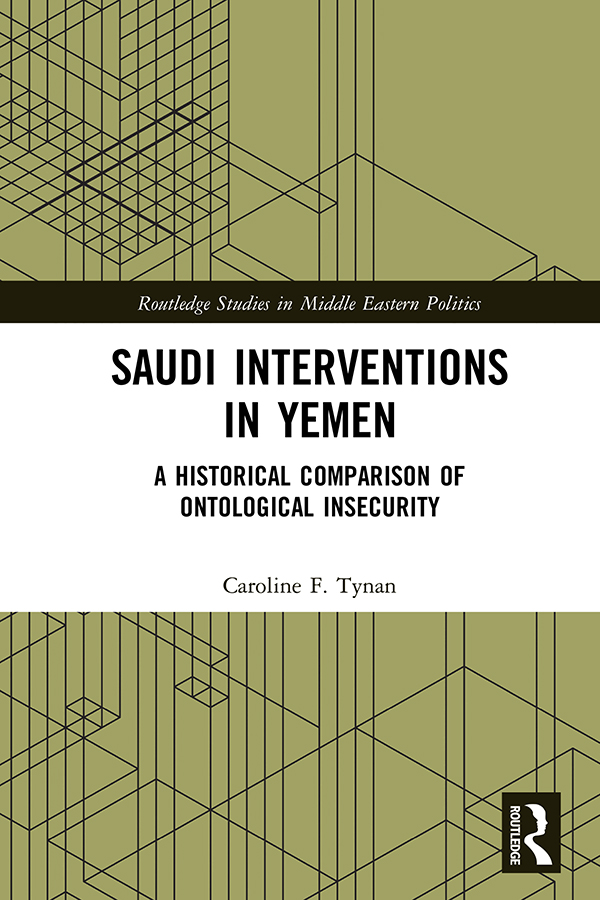
Saudi Interventions in Yemen This book explains the Saudi decision to launch a direct military intervention in Yemen in 2015 by comparing it with the monarchy’s response to Egyptian intervention into Yemen in 1962. It does so through the lens of domestic politics by tracing the monarchy’s response to the opposition in both time periods, and how this was informed by the different regional contexts of the 1960s and the 2011 Arab Spring. The study argues that Saudi Arabia enhanced its own institutions, including a pan-Islamic ideological justification to rule, in response to aggression from Egypt and its revolutionary pan-Arab ideology. This contributed to a relatively cautious Saudi foreign policy in response to regional threats from Arab nationalism, along with a strategy of co-optation within the kingdom. In contrast, the non-ideological threat embodied in the Arab Spring posed a more existential danger to Saudi legitimacy. The new crown prince manipulated the regime’s sense of anxiety from this to consolidate power through further scapegoating of the Shi’a minority, exacerbated tensions with foreign rivals, and, most blatantly, the 2015 intervention in Yemen. Comparing Saudi foreign policy changes from the Arab nationalist period to the post-Arab Spring period, this volume is a valuable resource for scholars and students interested in political science, history, international relations and Middle East politics. POLITICAL SCIENCE,World,Middle Eastern
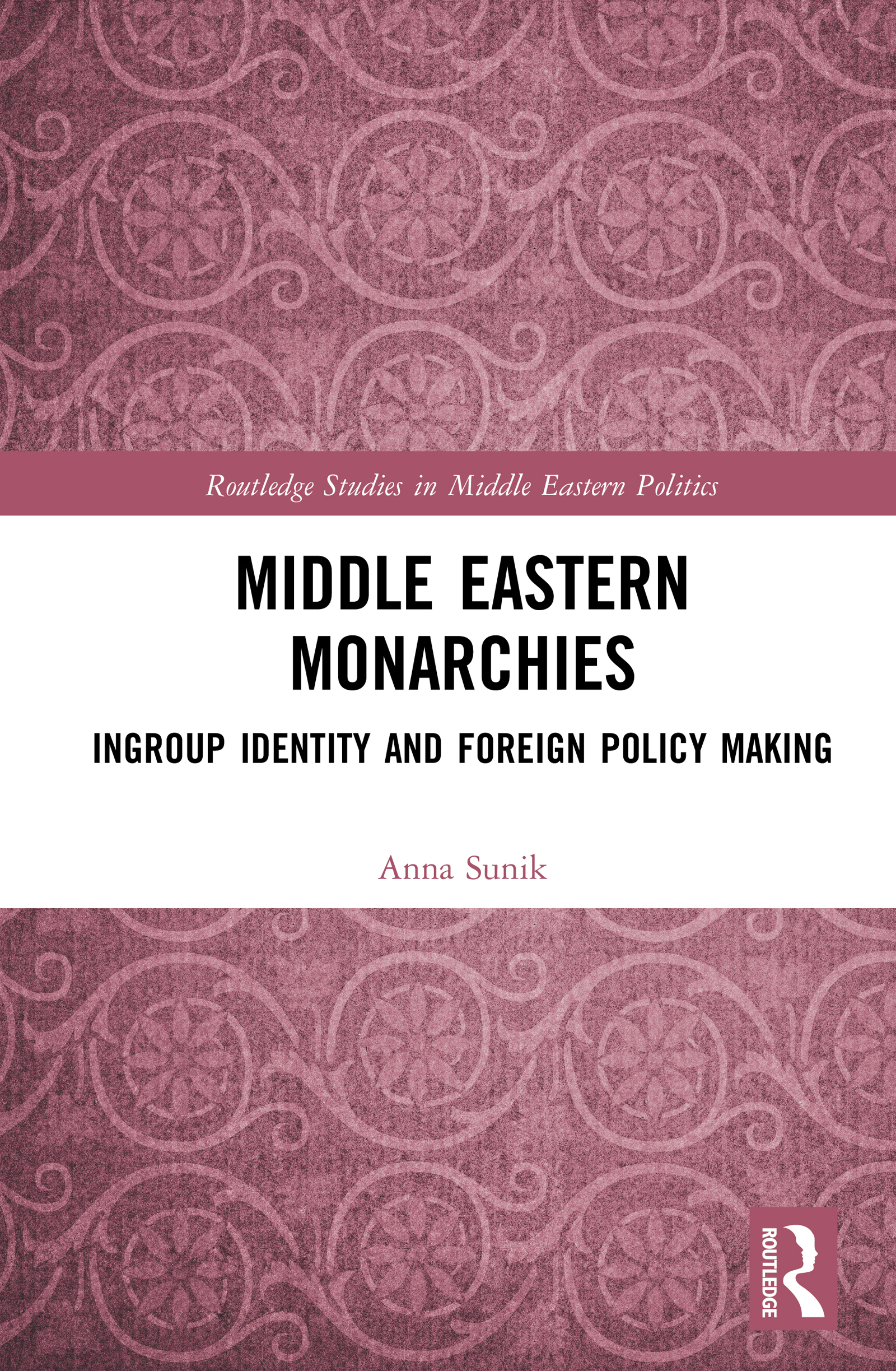
Middle Eastern Monarchies The monograph explores the dynamics of ingroup identity in the foreign policy-making of Middle Eastern monarchies from the evolution of the regional system after the World Wars until the present. Utilising an innovative theoretical framework that combines Foreign Policy Analysis in the context of authoritarian regimes and Social Identity Theory, the book theorizes the origins and inner workings of a "monarchic peace" among hereditary regimes in the Middle East, including the Gulf monarchies as well as Jordan and Morocco. While the phenomenon of the "democratic peace" is well established in political science, this book argues that like the examined "monarchic peace", it is, in fact, a sub-case of a broader Similar Political Systems Peace (SPSP). The theory posits that monarchies do not wage war against each other because they recognize each other as members of the same "ingroup" which allows for other mechanisms of conflict resolution – behaviour that is allowed against outsiders might be prohibited against members of the same club or "family". The theory is illustrated with numerous case studies that look at overall regional dynamics as well as four crucial cases of monarchic interstate conflict: Bahraini-Qatari relations, the Saudi-Hashemite rivalry, and the relations between Kuwait and Iraq and Iran and the UAE. This in-depth account of the foreign policies and community, connecting Middle Eastern monarchies will be of interest to readers in international relations, authoritarianism studies, Middle East and Persian Gulf politics. POLITICAL SCIENCE,World,Middle Eastern

Can Academics Change the World? Moshe Shokeid narrates his experiences as a member of AD KAN (NO MORE), a protest movement of Israeli academics at Tel Aviv University, who fought against the Israeli occupation of Palestinian territories, founded during the first Palestinian Intifada (1987-1993). However, since the assassination of Prime Minister Rabin and the later obliteration of the Oslo accord, public manifestations of dissent on Israeli campuses have been remarkably mute. This chronicle of AD KAN is explored in view of the ongoing theoretical discourse on the role of the intellectual in society and is compared with other account of academic involvement in different countries during periods of acute political conflict. POLITICAL SCIENCE,World,Middle Eastern
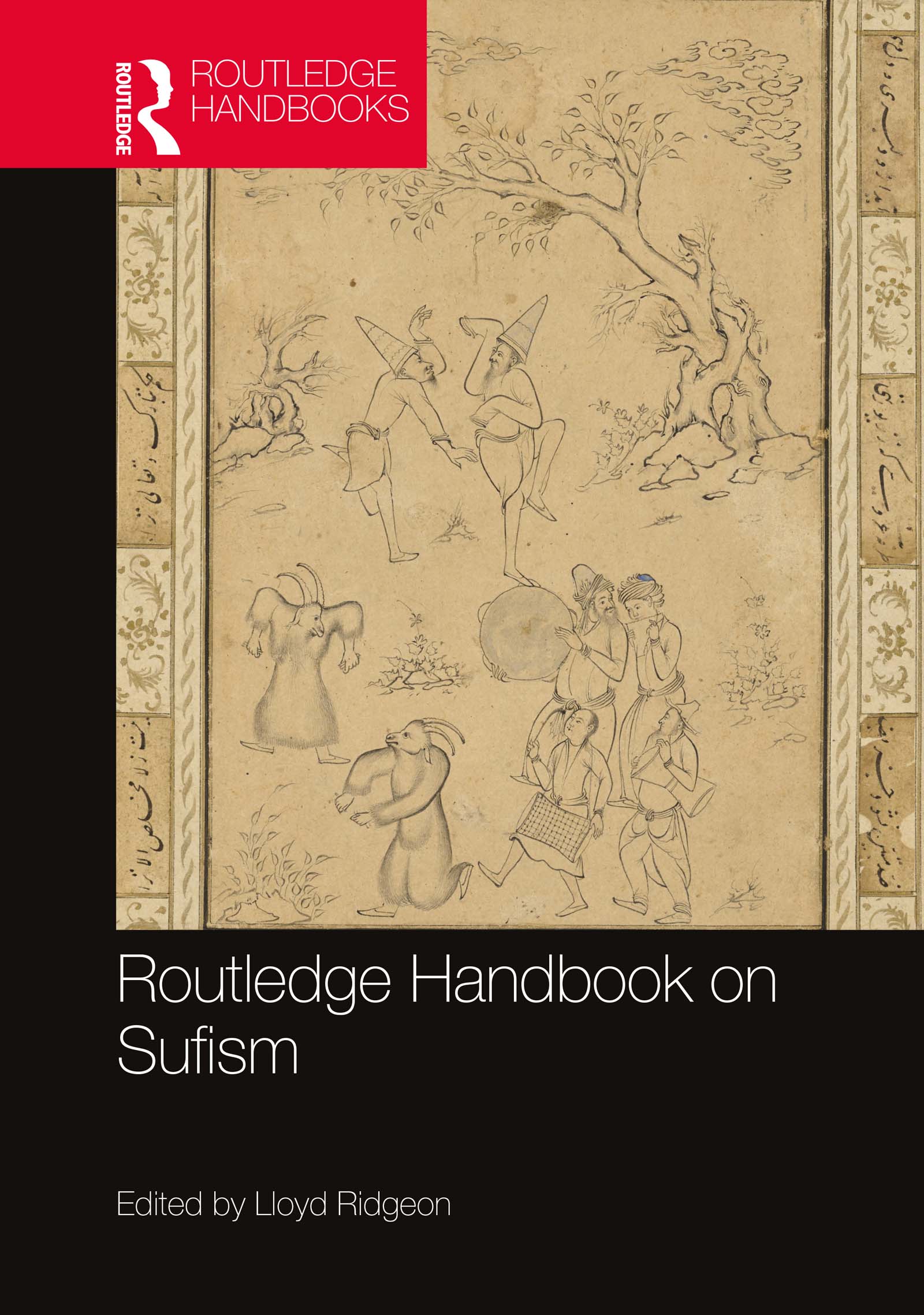
Routledge Handbook on Sufism This is a chronological history of the Sufi tradition, divided in to three sections, early, middle and modern periods. The book comprises 35 independent chapters with easily identifiable themes and/or geographical threads, all written by recognised experts in the field. The volume outlines the origins and early developments of Sufism by assessing the formative thinkers and practitioners and investigating specific pietistic themes. The middle period contains an examination of the emergence of the Sufi Orders and illustrates the diversity of the tradition. This middle period also analyses the fate of Sufism during the time of the Gunpowder Empires. Finally, the end period includes representative surveys of Sufism in several countries, both in the West and in traditional "Islamic" regions. This comprehensive and up-to-date collection of studies provides a guide to the Sufi tradition. The Handbook is a valuable resource for students and researchers with an interest in religion, Islamic Studies and Middle Eastern Studies. POLITICAL SCIENCE,World,Middle Eastern
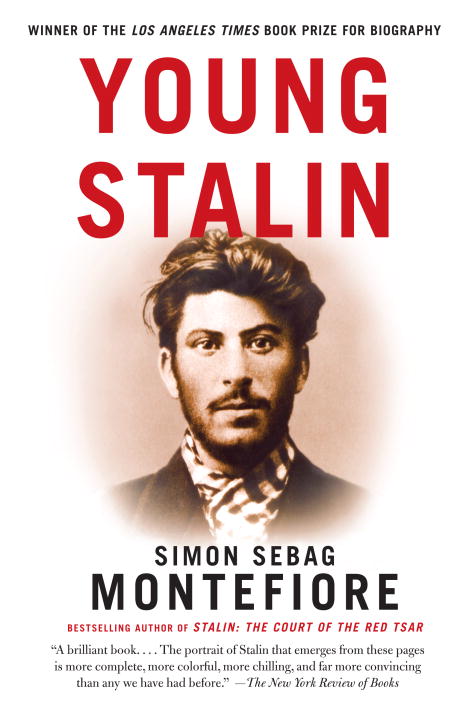
Young Stalin This revelatory account unveils how Stalin became Stalin, examining his shadowy journey from obscurity to power—from master historian Simon Sebag Montefiore. Based on ten years of research, Young Stalin—companion to the prizewinning Stalin: The Court of the Red Tsar—is a brilliant prehistory of the USSR, a chronicle of the Revolution, and an intimate biography. Montefiore tells the story of a charismatic, darkly turbulent boy born into poverty, scarred by his upbringing but possessed of unusual talents. Admired as a romantic poet and trained as a priest, he found his true mission as a murderous revolutionary. Here is the dramatic story of his friendships and hatreds, his many love affairs, his complicated relationship with the Tsarist secret police, and how he became the merciless politician who shaped the Soviet Empire in his own brutal image. Described by The New York Times as "a meticulously researched, autoritative biography," Young Stalin is essential reading for anyone interested in Russian history. Winner of the Costa Book Award for Biography A Christian Science Monitor and Seattle Times Best Book of the Year POLITICAL SCIENCE,World,Russian & Former Soviet Union
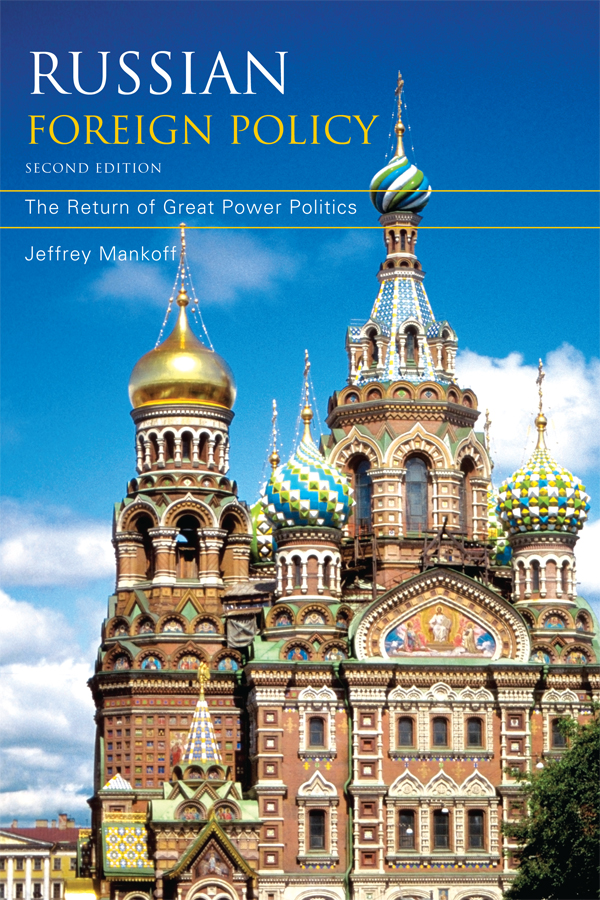
Russian Foreign Policy Now thoroughly updated, this widely praised book provides a thoughtful and balanced examination of the development of Russian foreign policy since the end of the Cold War. This edition also places developments of the past two decades into the broader sweep of Russian history. Presenting an even-handed treatment of controversial issues, Jeffrey Mankoff analyzes Russia's interactions with major global actors, including the United States, the European Union, the Commonwealth of Independent States, and China. The author convincingly demonstrates that despite Moscow's often-harsh rhetoric, today's Russia is more interested in restoring what its leaders consider to be its rightful place among the world's major powers than in directly challenging the West. Thoroughly researched and knowledgeable, this book will be invaluable for all readers interested in Russia. POLITICAL SCIENCE,World,Russian & Former Soviet Union

Politics, Murder, and Love in Stalin's Kremlin Drawing from Hoover Institution archival documents, Paul Gregory sheds light on how the world's first socialist state went terribly wrong and why it was likely to veer off course through the tragic story of Stalin's most prominent victims: Pravda editor Nikolai Bukharin and his wife, Anna Larina. POLITICAL SCIENCE,World,Russian & Former Soviet Union
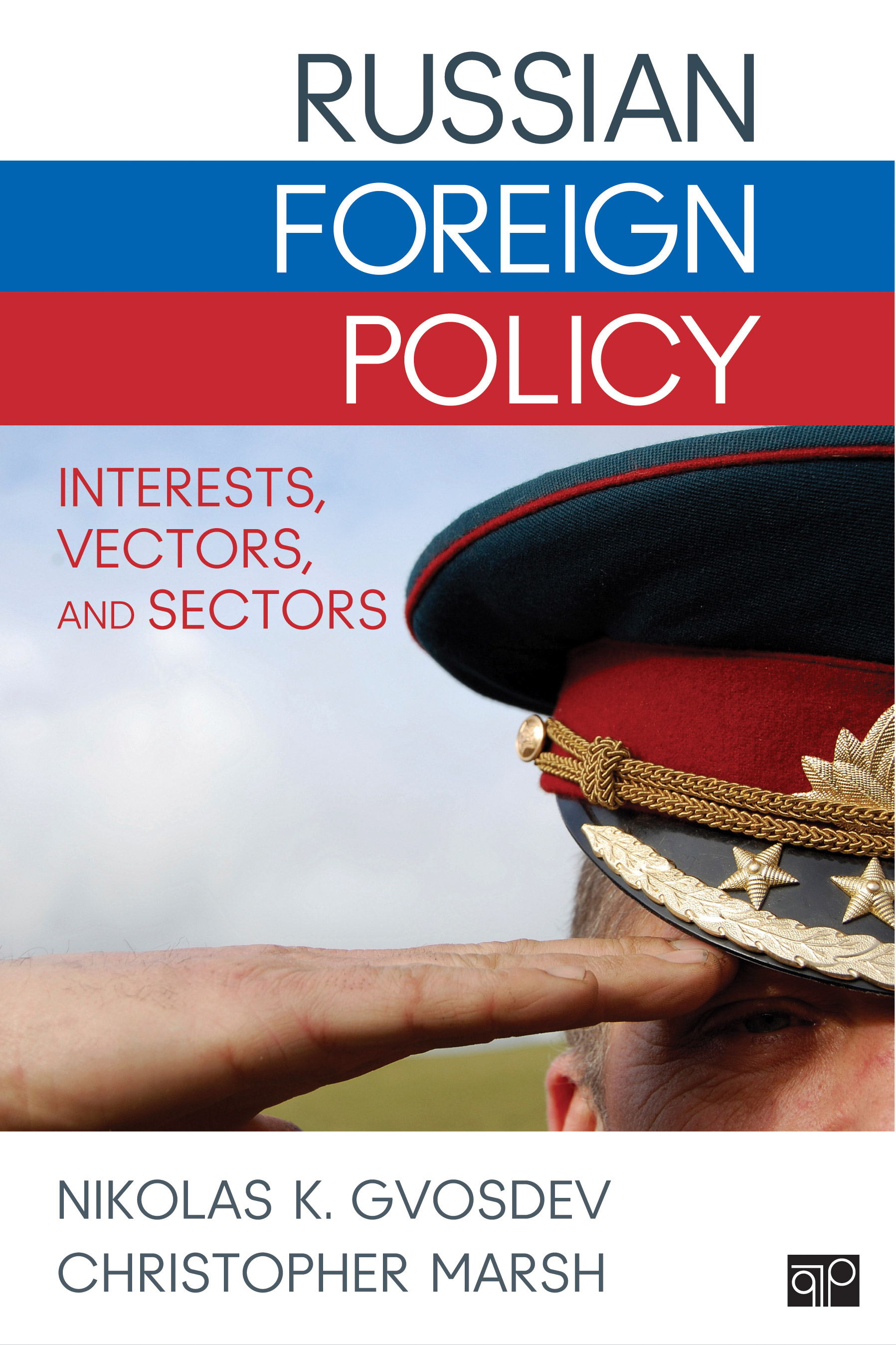
Russian Foreign Policy In a truly contemporary analysis of Moscow's relations with its neighbors and other strategic international actors, Nikolas K. Gvosdev and Christopher Marsh use a comprehensive vectors approach, dividing the world into eight geographic zones. Each vector chapter looks at the dynamics of key bilateral relationships while highlighting major topical issues—oil and energy, defense policy, economic policy, the role of international institutions, and the impact of major interest groups or influencers—demonstrating that Russia formulates multiple, sometimes contrasting, foreign policies. Providing rich historical context as well as exposure to the scholarly literature, Russian Foreign Policy: Interests, Vectors, and Sectors offers an incisive look at how and why Russia partners with some states while it counter-balances others. POLITICAL SCIENCE,World,Russian & Former Soviet Union
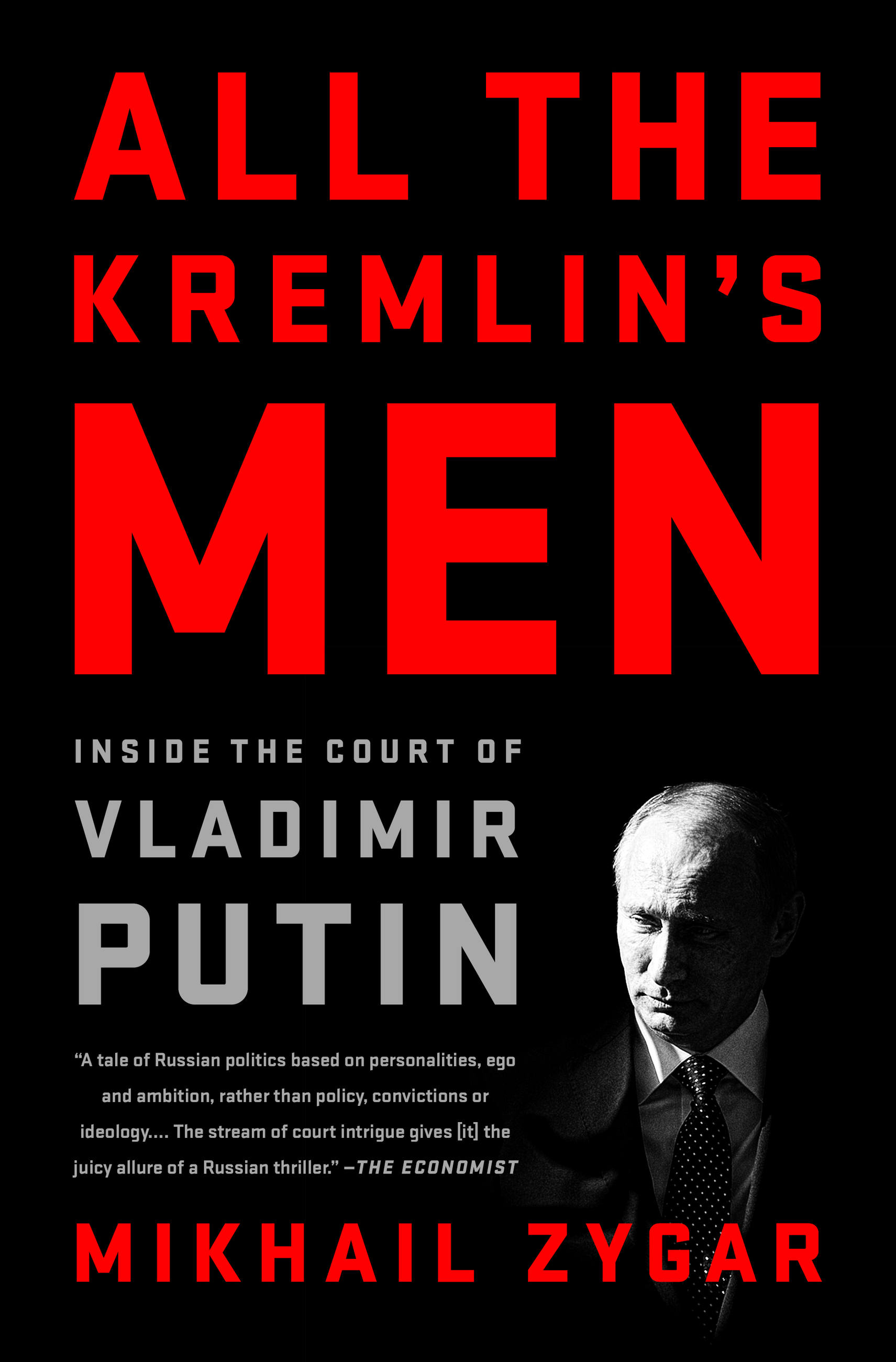
All the Kremlin's Men An extraordinary behind-the-scenes portrait of the court of Vladimir Putin, the oligarchs that surround it, and the many moods of modern Russia that reads like a "real House of Cards"(Lev Lurie). All the Kremlin's Men is a gripping narrative of an accidental king and a court out of control. Based on an unprecedented series of interviews with Vladimir Putin's inner circle, this book presents a radically different view of power and politics in Russia. The image of Putin as a strongman is dissolved. In its place is a weary figurehead buffeted -- if not controlled -- by the men who at once advise and deceive him. The regional governors and bureaucratic leaders are immovable objects, far more powerful in their fiefdoms than the president himself. So are the gatekeepers-those officials who guard the pathways to power-on whom Putin depends as much as they rely on him. The tenuous edifice is filled with all of the intrigue and plotting of a Medici court, as enemies of the state are invented and wars begun to justify personal gains, internal rivalries, or one faction's biased advantage. A bestseller in Russia, All the Kremlin's Men is a shocking revisionist portrait of the Putin era and a dazzling reconstruction of the machinations of courtiers running riot. POLITICAL SCIENCE,World,Russian & Former Soviet Union
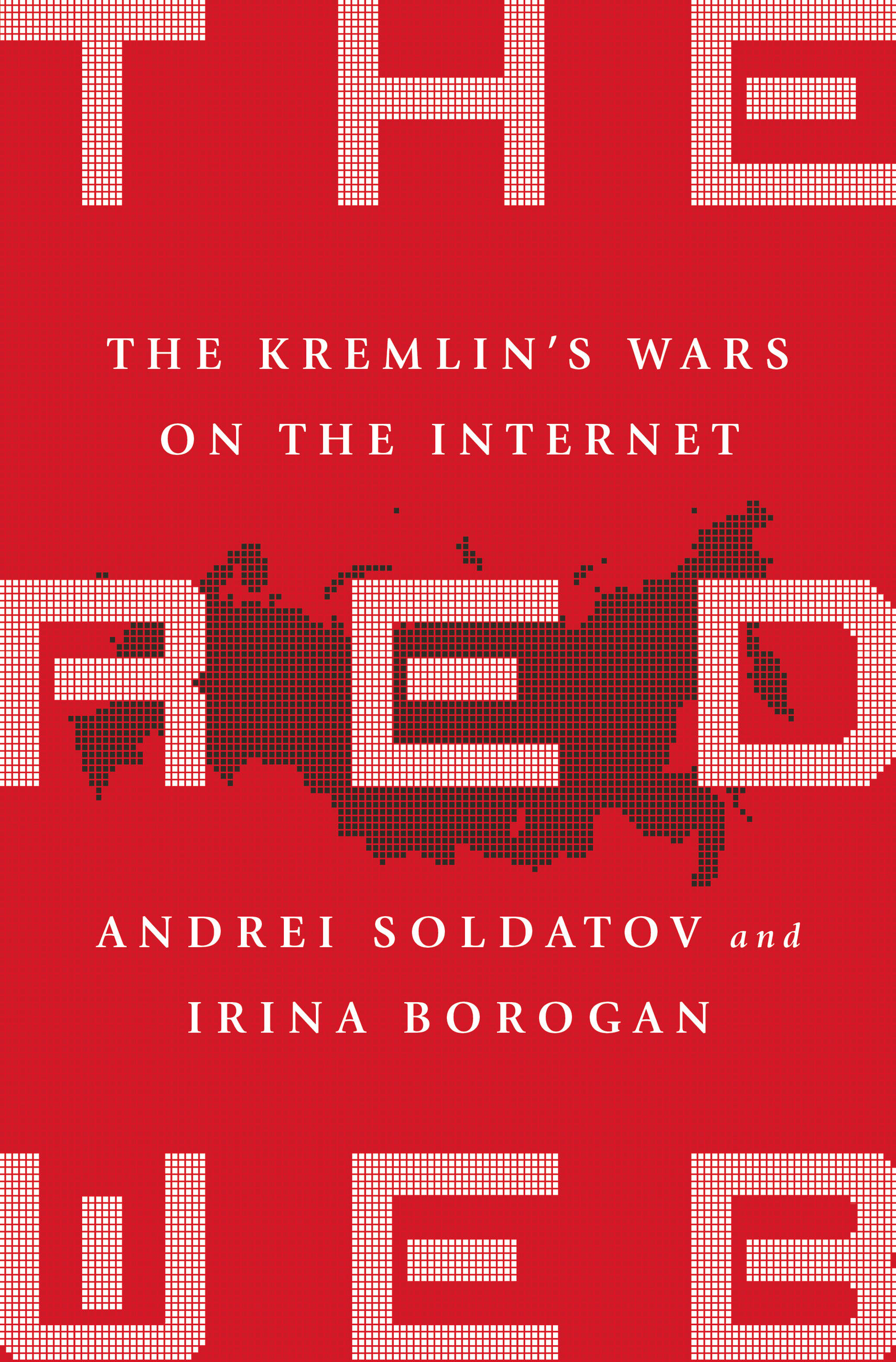
The Red Web A Library Journal Best Book of 2015 A NPR Great Read of 2015 The Internet in Russia is either the most efficient totalitarian tool or the device by which totalitarianism will be overthrown. Perhaps both. On the eighth floor of an ordinary-looking building in an otherwise residential district of southwest Moscow, in a room occupied by the Federal Security Service (FSB), is a box the size of a VHS player marked SORM. The Russian government's front line in the battle for the future of the Internet, SORM is the world's most intrusive listening device, monitoring e-mails, Internet usage, Skype, and all social networks. But for every hacker subcontracted by the FSB to interfere with Russia's antagonists abroad -- such as those who, in a massive denial-of-service attack, overwhelmed the entire Internet in neighboring Estonia -- there is a radical or an opportunist who is using the web to chip away at the power of the state at home. Drawing from scores of interviews personally conducted with numerous prominent officials in the Ministry of Communications and web-savvy activists challenging the state, Andrei Soldatov and Irina Borogan peel back the history of advanced surveillance systems in Russia. From research laboratories in Soviet-era labor camps, to the legalization of government monitoring of all telephone and Internet communications in the 1990s, to the present day, their incisive and alarming investigation into the Kremlin's massive online-surveillance state exposes just how easily a free global exchange can be coerced into becoming a tool of repression and geopolitical warfare. Dissidents, oligarchs, and some of the world's most dangerous hackers collide in the uniquely Russian virtual world of The Red Web. POLITICAL SCIENCE,World,Russian & Former Soviet Union
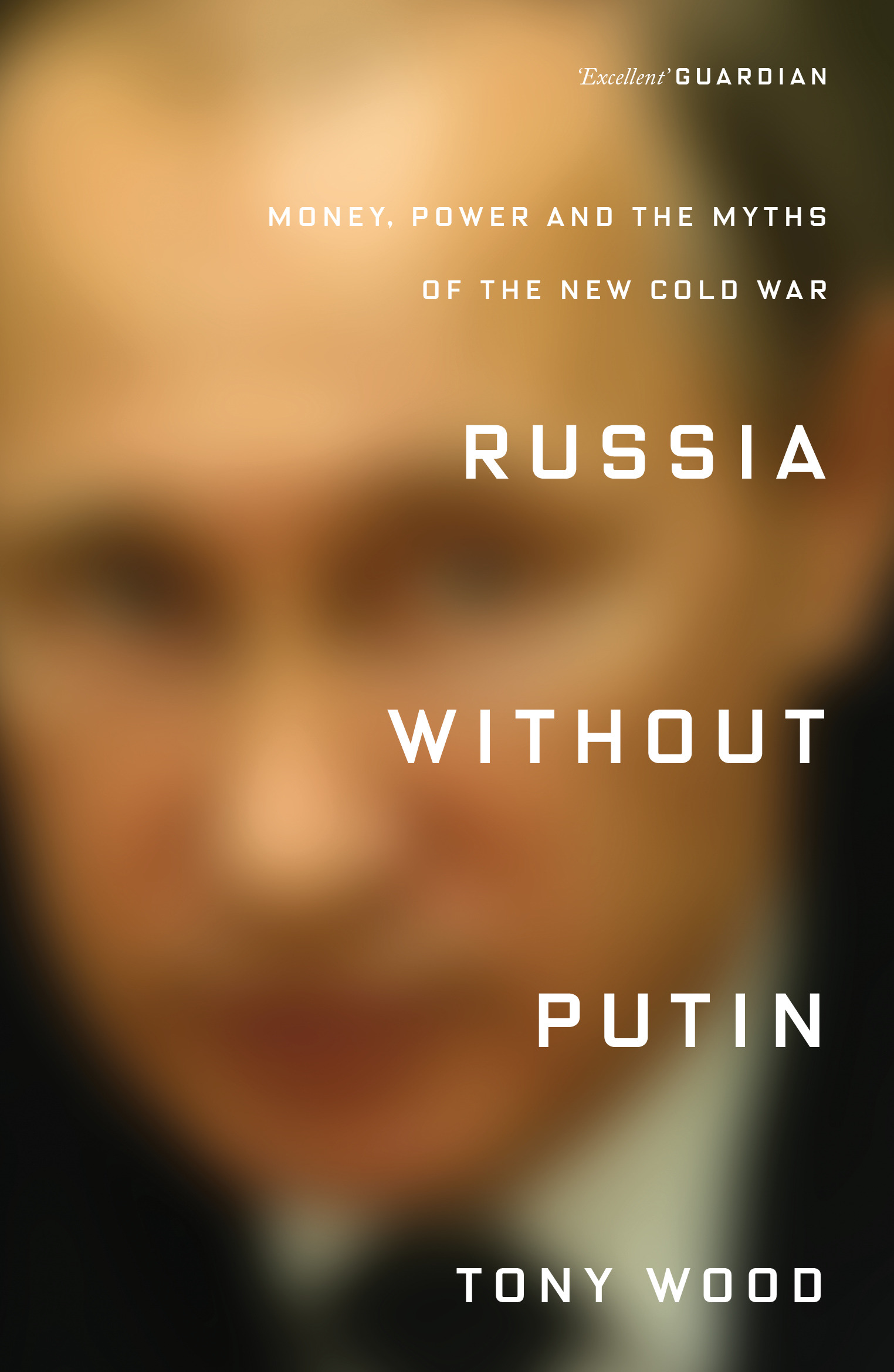
Russia Without Putin How the West’s obsession with Vladimir Putin prevents it from understanding Russia It is impossible to think of Russia today without thinking of Vladimir Putin. More than any other major national leader, he personifies his country in the eyes of the world, and dominates Western media coverage. In Russia itself, he is likewise the centre of attention both for his supporters and his detractors. But, as Tony Wood argues, this focus on Russia’s president gets in the way of any real understanding of the country. The West needs to shake off its obsession with Putin and look beyond the Kremlin walls. In this timely and provocative analysis, Wood explores the profound changes Russia has undergone since 1991. In the process, he challenges several common assumptions made about contemporary Russia. Against the idea that Putin represents a return to Soviet authoritarianism, Wood argues that his rule should be seen as a continuation of Yeltsin’s in the 1990s. The core features of Putinism—a predatory elite presiding over a vastly unequal society—are in fact integral to the system set in place after the fall of Communism. Wood also overturns the standard view of Russia’s foreign policy, identifying the fundamental loss of power and influence that has underpinned recent clashes with the West. Russia without Putin concludes by assessing the current regime’s prospects, and looks ahead to what the future may hold for the country. POLITICAL SCIENCE,World,Russian & Former Soviet Union
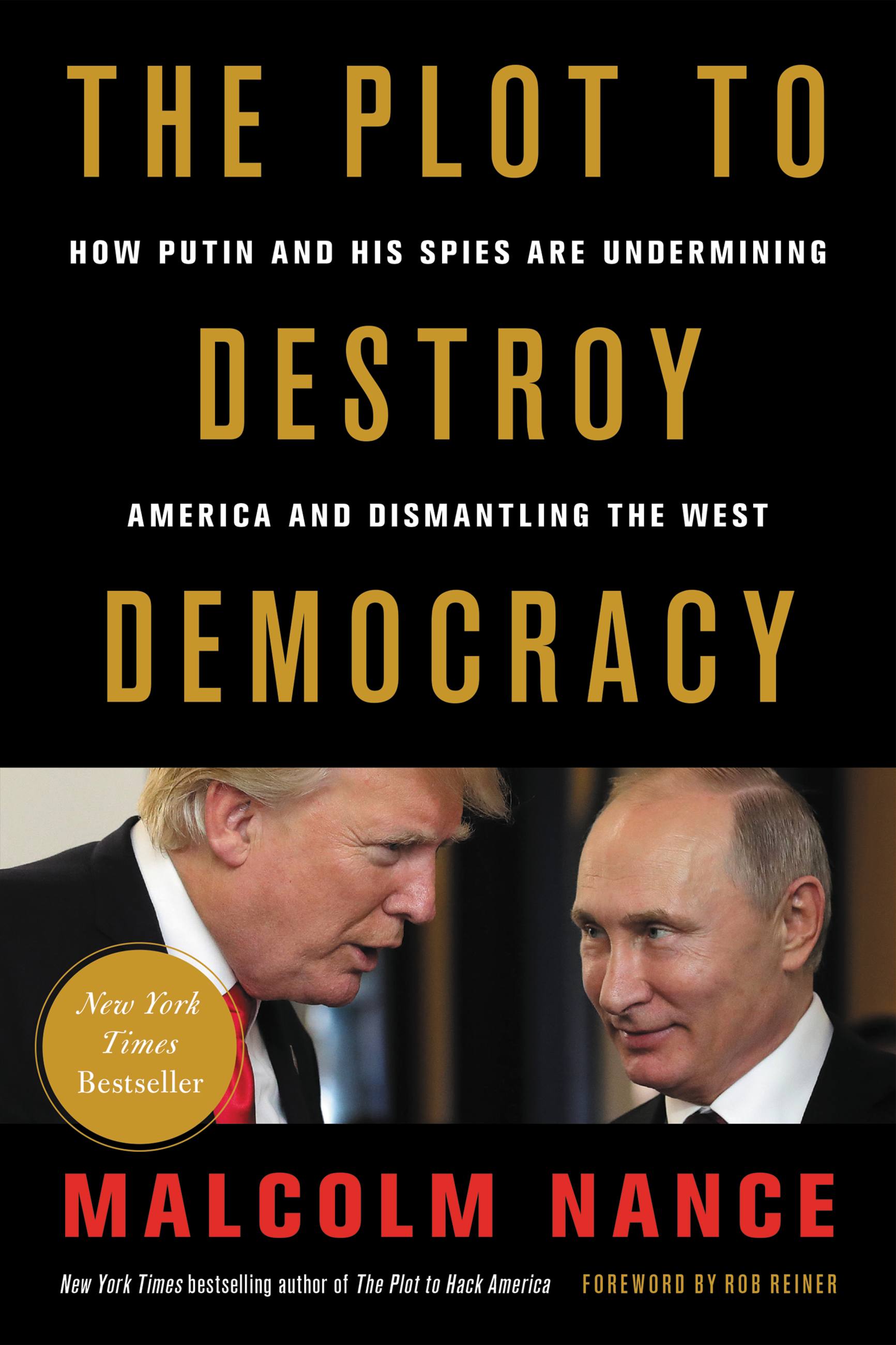
The Plot to Destroy Democracy A provocative, comprehensive analysis of Vladimir Putin and Russia's master plan to destroy democracy in the age of Donald Trump. In the greatest intelligence operation in the history of the world, Donald Trump was made President of the United States with the assistance of a foreign power. For the first time, The Plot to Destroy Democracy reveals the dramatic story of how blackmail, espionage, assassination, and psychological warfare were used by Vladimir Putin and his spy agencies to steal the 2016 U.S. election -- and attempted to bring about the fall of NATO, the European Union, and western democracy. It will show how Russia and its fifth column allies tried to flip the cornerstones of democracy in order to re-engineer the world political order that has kept most of the world free since 1945. Career U.S. Intelligence officer Malcolm Nance will examine how Russia has used cyber warfare, political propaganda, and manipulation of our perception of reality -- and will do so again -- to weaponize American news, traditional media, social media, and the workings of the internet to attack and break apart democratic institutions from within, and what we can expect to come should we fail to stop their next attack. Nance has utilized top secret Russian-sourced political and hybrid warfare strategy documents to demonstrate the master plan to undermine American institutions that has been in effect from the Cold War to the present day. Based on original research and countless interviews with espionage experts, Nance examines how Putin's recent hacking accomplished a crucial first step for destabilizing the West for Russia, and why Putin is just the man to do it. Nance exposes how Russia has supported the campaigns of right-wing extremists throughout both the U.S. and Europe to leverage an axis of autocracy, and how Putin's agencies have worked since 2010 to bring fringe candidate Donald Trump into elections. Revelatory, insightful, and shocking, The Plot To Destroy Democracy puts a professional spy lens on Putin's plot and unravels it play-by-play. In the end, he provides a better understanding of why Putin's efforts are a serious threat to our national security and global alliances -- in much more than one election -- and a blistering indictment of Putin's puppet, President Donald J. Trump. POLITICAL SCIENCE,World,Russian & Former Soviet Union

Routledge Handbook of Russian Foreign Policy Providing a comprehensive overview of Russia’s foreign policy directions, this handbook brings together an international team of scholars to develop a complex treatment of Russia’s foreign policy. The chapters draw from numerous theoretical traditions by incorporating ideas of domestic institutions, considerations of national security and international recognition as sources of the nation’s foreign policy. Covering critically important subjects such as Russia’s military interventions in Ukraine and Syria, the handbook is divided into four key parts: Part I explores the social and material conditions in which Russia’s foreign policy is formed and implemented. Part II investigates tools and actors that participate in policy making including diplomacy, military, media, and others. Part III provides an overview of Russia’s directions towards the United States, Europe, Asia, the Middle East, Eurasia, and the Arctic. Part IV addresses the issue of Russia’s participation in global governance and multiple international organizations, as well as the Kremlin’s efforts to build new organizations and formats that suit Russia’s objectives. The Routledge Handbook of Russian Foreign Policy is an invaluable resource to students and scholars of Russian Politics and International Relations, as well as World Politics more generally. POLITICAL SCIENCE,World,Russian & Former Soviet Union
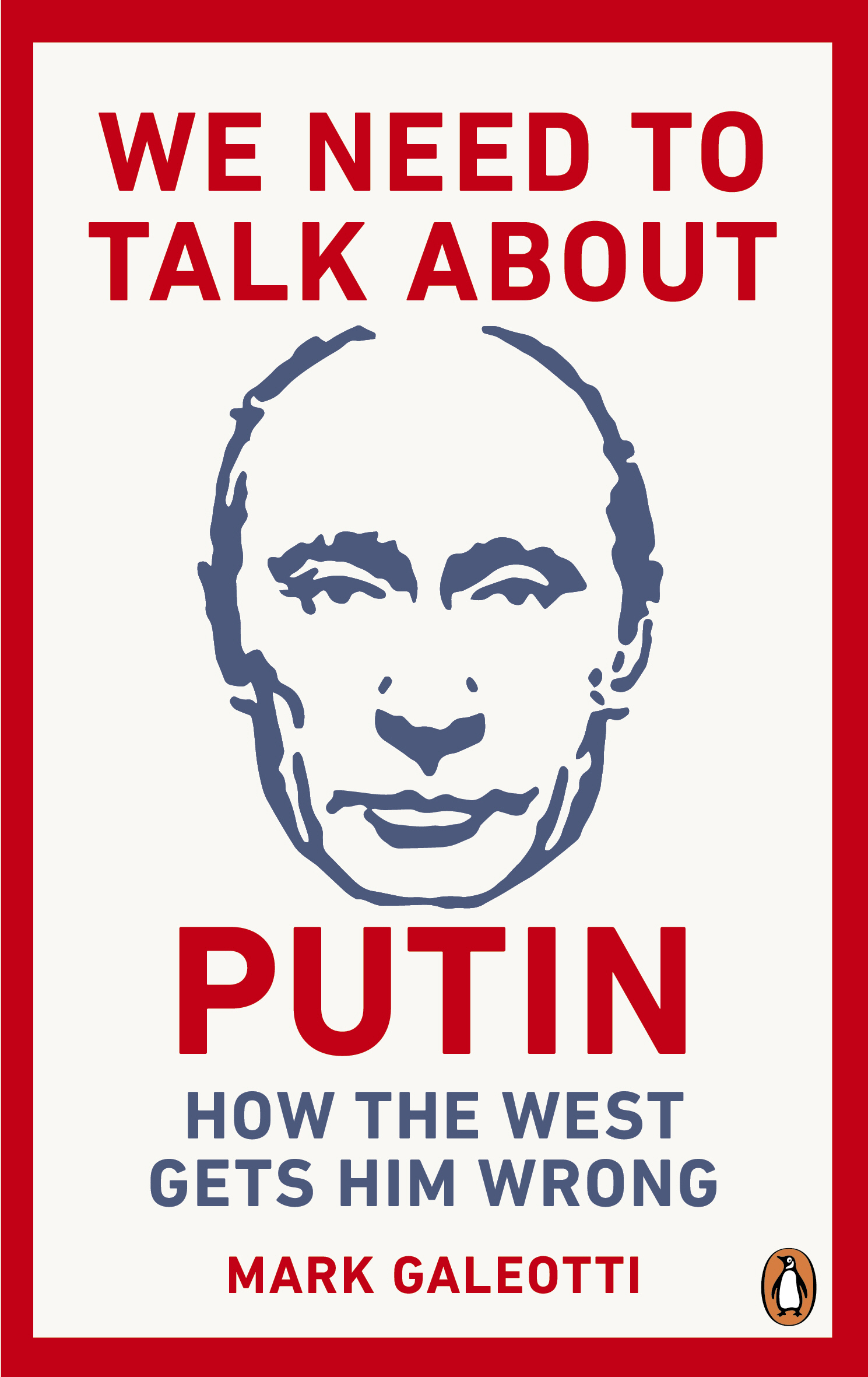
We Need to Talk About Putin A The Times best book of 2019 'In fewer than 150 pithy pages, Galeotti sketches a bleak, but convincing picture of the man in the Kremlin and the political system that he dominates' - The Times Meet the world's most dangerous man. Or is he? Who is the real Vladimir Putin? What does he want? And what will he do next? Despite the millions of words written on Putin's Russia, the West still fails to truly understand one of the world's most powerful politicians, whose influence spans the globe and whose networks of power reach into the very heart of our daily lives. In this essential primer, Professor Mark Galeotti uncovers the man behind the myth, addressing the key misperceptions of Putin and explaining how we can decipher his motivations and next moves. From Putin’s early life in the KGB and his real relationship with the USA to his vision for the future of Russia – and the world – Galeotti draws on new Russian sources and explosive unpublished accounts to give unparalleled insight into the man at the heart of global politics. POLITICAL SCIENCE,World,Russian & Former Soviet Union
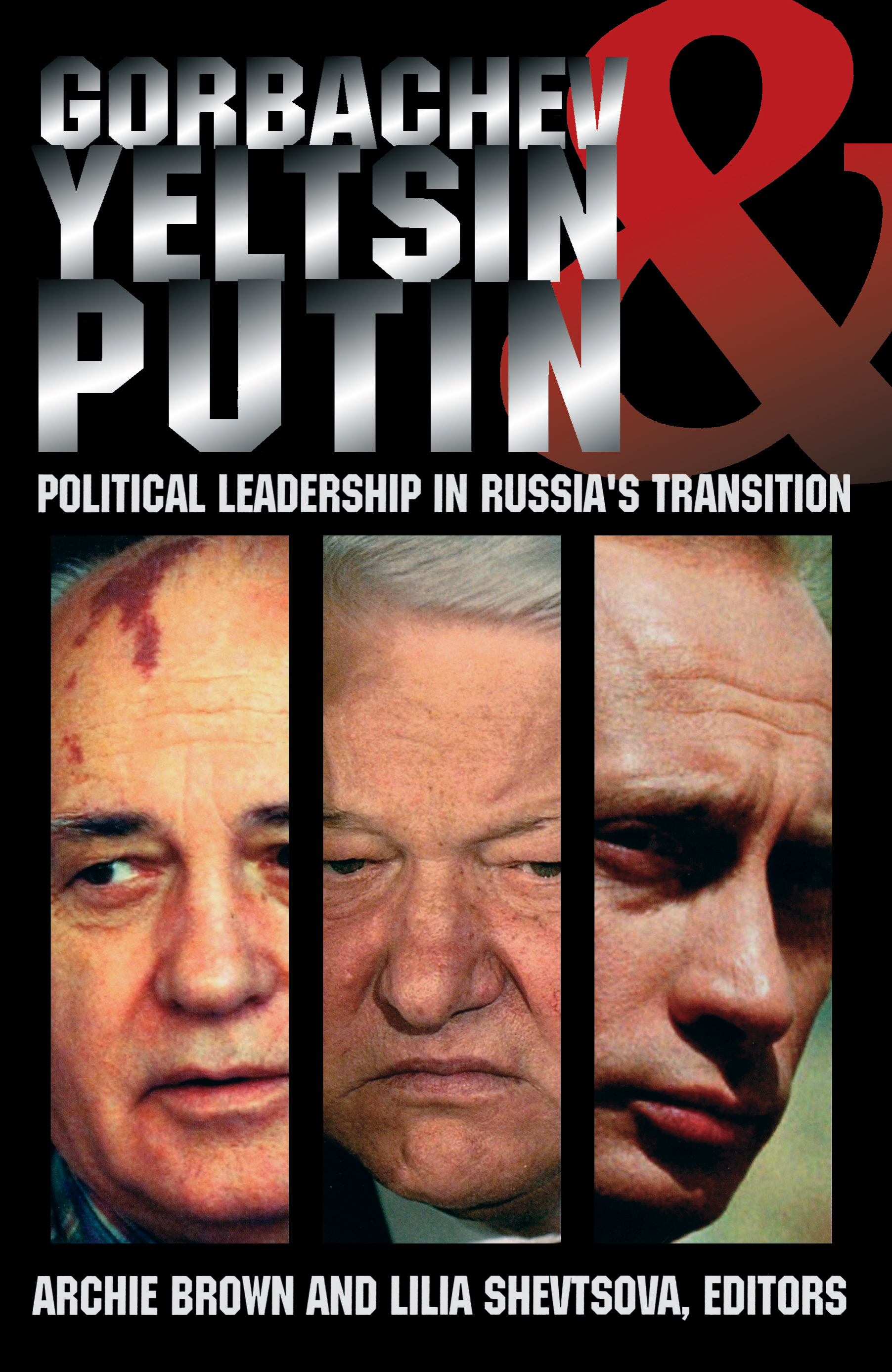
Gorbachev, Yeltsin, and Putin This volume analyzes various aspects of the political leadership during the collapse of the Soviet Union and formation of a new Russia. Comparing the rule of Mikhail Gorbachev, Boris Yeltsin, and Vladimir Putin, the book reflects upon their goals, governing style, and sources of influenceas well as factors that influenced their activities and complicated them too. Contents Introduction Archie Brown Transformational Leaders Compared: Mikhail Gorbachev and Boris Yeltsin Archie Brown Evaluating Gorbachev and Yeltsin as Leaders George W. Breslauer From Yeltsin to Putin: The Evolution of Presidential Power Lilia Shevtsova Political Leadership and the Center-Periphery Struggle: Putin's Administrative Reforms Eugene Huskey Conclusion Lilia Shevtsova POLITICAL SCIENCE,World,Russian & Former Soviet Union
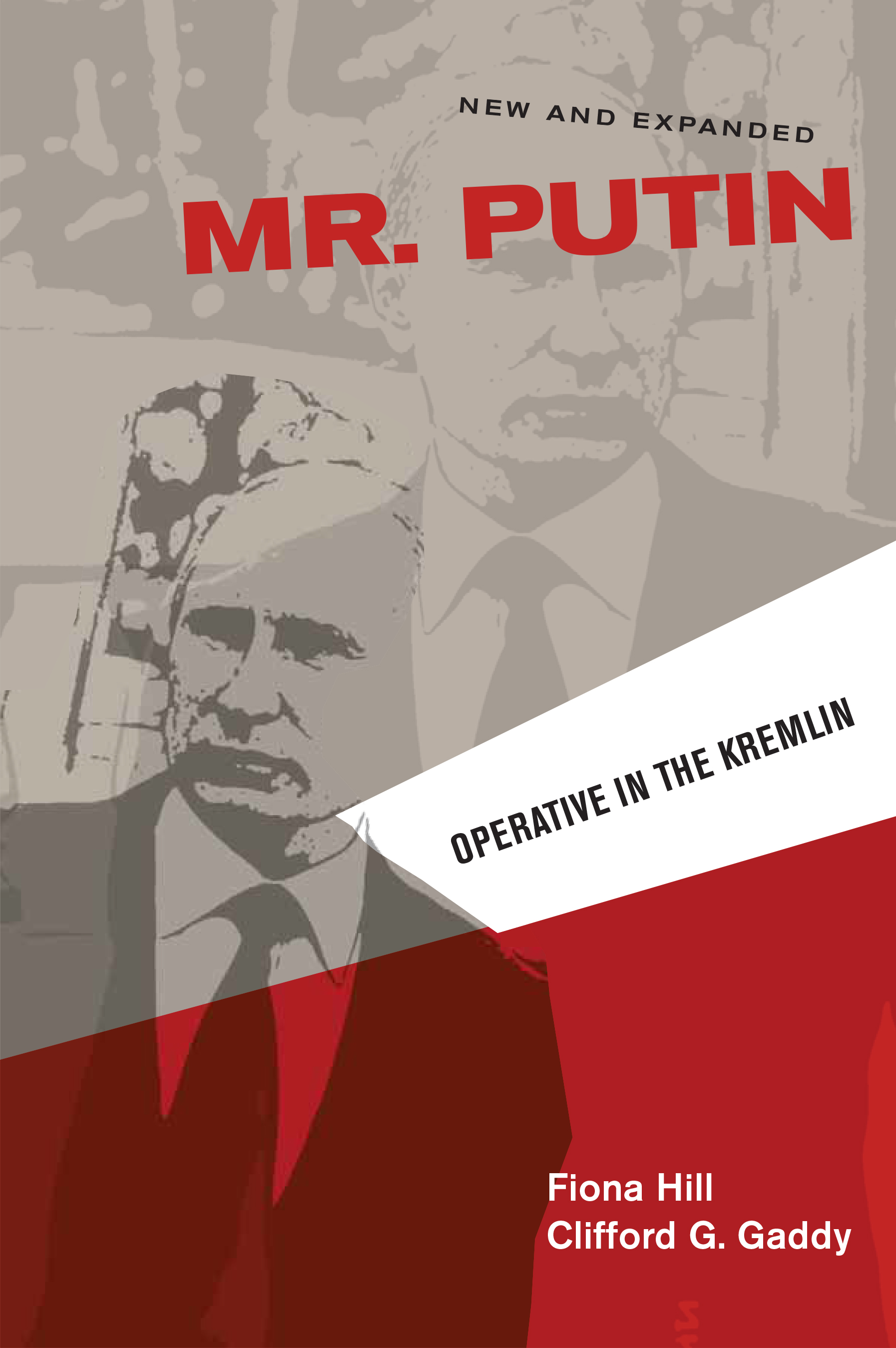
Mr. Putin Fiona Hill and other U.S. public servants have been recognized as Guardians of the Year in TIME’s 2019 Person of the Year issue. From the KGB to the Kremlin: a multidimensional portrait of the man at war with the West. Where do Vladimir Putin's ideas come from? How does he look at the outside world? What does he want, and how far is he willing to go? The great lesson of the outbreak of World War I in 1914 was the danger of misreading the statements, actions, and intentions of the adversary. Today, Vladimir Putin has become the greatest challenge to European security and the global world order in decades. Russia's 8,000 nuclear weapons underscore the huge risks of not understanding who Putin is. Featuring five new chapters, this new edition dispels potentially dangerous misconceptions about Putin and offers a clear-eyed look at his objectives. It presents Putin as a reflection of deeply ingrained Russian ways of thinking as well as his unique personal background and experience. Praise for the first edition: If you want to begin to understand Russia today, read this book.Sir John Scarlett, former chief of the British Secret Intelligence Service (MI6) For anyone wishing to understand Russia's evolution since the breakup of the Soviet Union and its trajectory since then, the book you hold in your hand is an essential guide.John McLaughlin, former deputy director of U.S. Central Intelligence Of the many biographies of Vladimir Putin that have appeared in recent years, this one is the most useful.Foreign Affairs This is not just another Putin biography. It is a psychological portrait.The Financial Times Q: Do you have time to read books? If so, which ones would you recommend? My goodness, let's see. There's Mr. Putin, by Fiona Hill and Clifford Gaddy. Insightful.Vice President Joseph Biden in Joe Biden: The Rolling Stone Interview. POLITICAL SCIENCE,World,Russian & Former Soviet Union
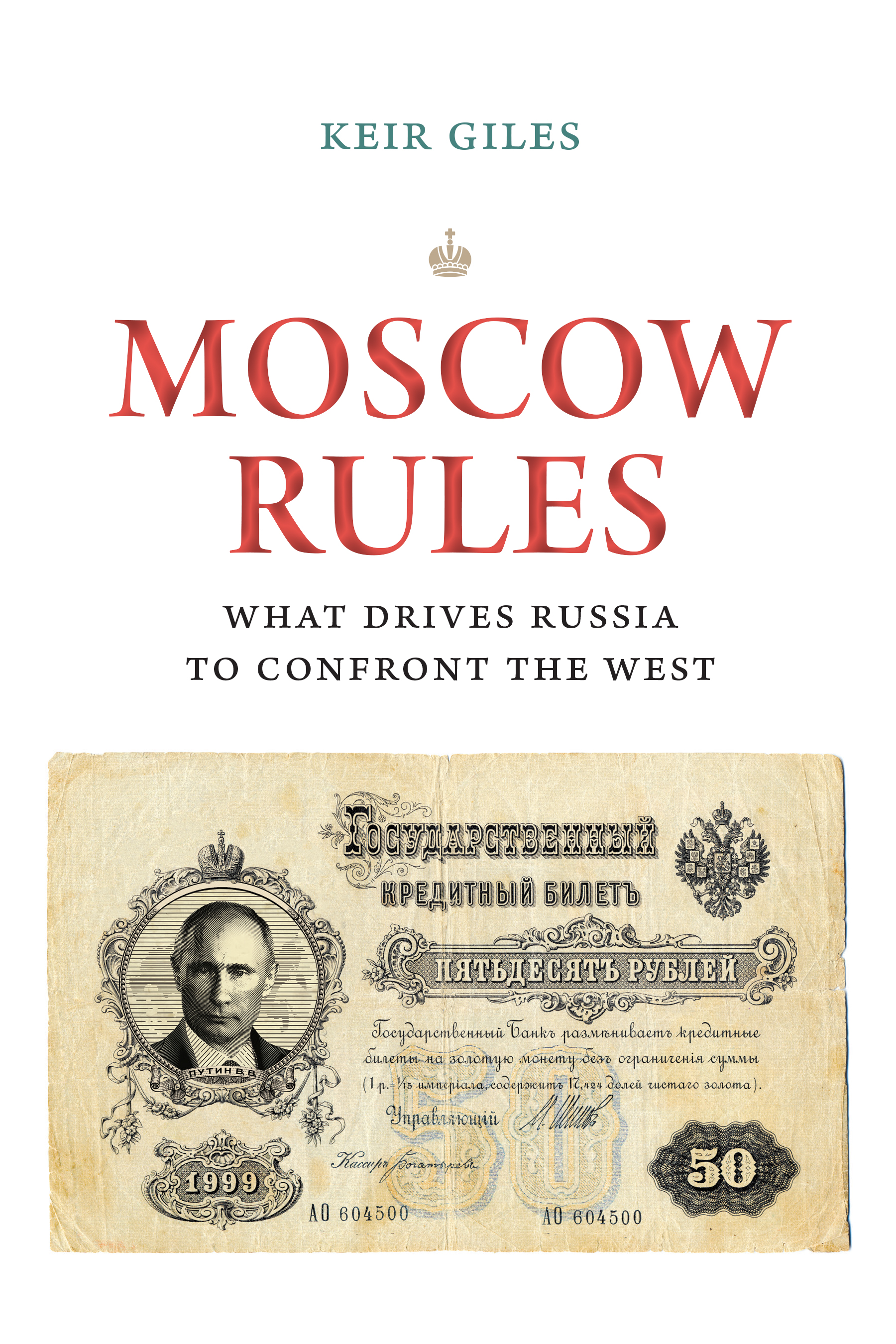
Moscow Rules From Moscow, the world looks different. It is through understanding how Russia sees the worldand its place in itthat the West can best meet the Russian challenge. Russia and the West are like neighbors who never seem able to understand each other. A major reason, this book argues, is that Western leaders tend to think that Russia should act as a rational Western nationeven though Russian leaders for centuries have thought and acted based on their country's much different history and traditions. Russia, through Western eyes, is unpredictable and irrational, when in fact its leaders from the czars to Putin almost always act in their own very predictable and rational ways. For Western leaders to try to engage with Russia without attempting to understand how Russians look at the world is a recipe for repeated disappointment and frequent crises. Keir Giles, a senior expert on Russia at Britain's prestigious Chatham House, describes how Russian leaders have used consistent doctrinal and strategic approaches to the rest of the world. These approaches may seem deeply alien in the West, but understanding them is essential for successful engagement with Moscow. Giles argues that understanding how Moscow's leaders thinknot just Vladimir Putin but his predecessors and eventual successorswill help their counterparts in the West develop a less crisis-prone and more productive relationship with Russia. POLITICAL SCIENCE,World,Russian & Former Soviet Union
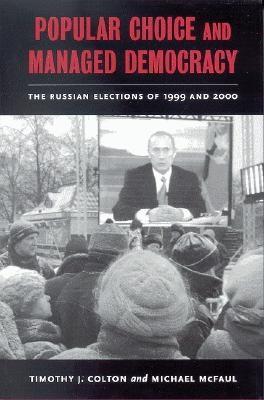
Popular Choice and Managed Democracy Twice in the winter of 1999-2000, citizens of the Russian Federation flocked to their neighborhood voting stations and scratched their ballots in an atmosphere of uncertainty, rancor, and fear. This book is a tale of these two electionsone for the 450-seat Duma, the other for President. Despite financial crisis, a national security emergency in Chechnya, and cabinet instability, Russian voters unexpectedly supported the status quo. The elected lawmakers prepared to cooperate with the executive branch, a gift that had eluded President Boris Yeltsin since he imposed a post-Soviet constitution by referendum in 1993. When Yeltsin retired six months in advance of schedule, the presidential mantle went to Vladimir Putina career KGB officer who fused new and old ways of doing politics. Putin was easily elected President in his own right. This book demonstrates key trends in an extinct superpower, a troubled country in whose stability, modernization, and openness to the international community the West still has a huge stake. POLITICAL SCIENCE,World,Russian & Former Soviet Union

The Russia Trap “A must read for anyone who cares about our nation's security in these cyber-serious, hair-trigger times.†– Susan Eisenhower Every American president since the end of the Cold War has called for better relations with Russia. But each has seen relations get worse by the time he left office. Now the two countries are facing off in a virtual war being fought without clear goals or boundaries. Why? Many say it is because Washington has been slow to wake up to Russian efforts to destroy democracy in America and the world. But a former head of Russia analysis at the CIA says that this misunderstands the problem. George Beebe argues that new game-changing technologies, disappearing rules of the game, and distorted perceptions on both sides are combining to lock Washington and Moscow into an escalatory spiral that they do not recognize. All the pieces are in place for a World War I-type tragedy that could be triggered by a small, unpredictable event. The Russia Trap shows that anticipating this danger is the most important step in preventing it. POLITICAL SCIENCE,World,Russian & Former Soviet Union
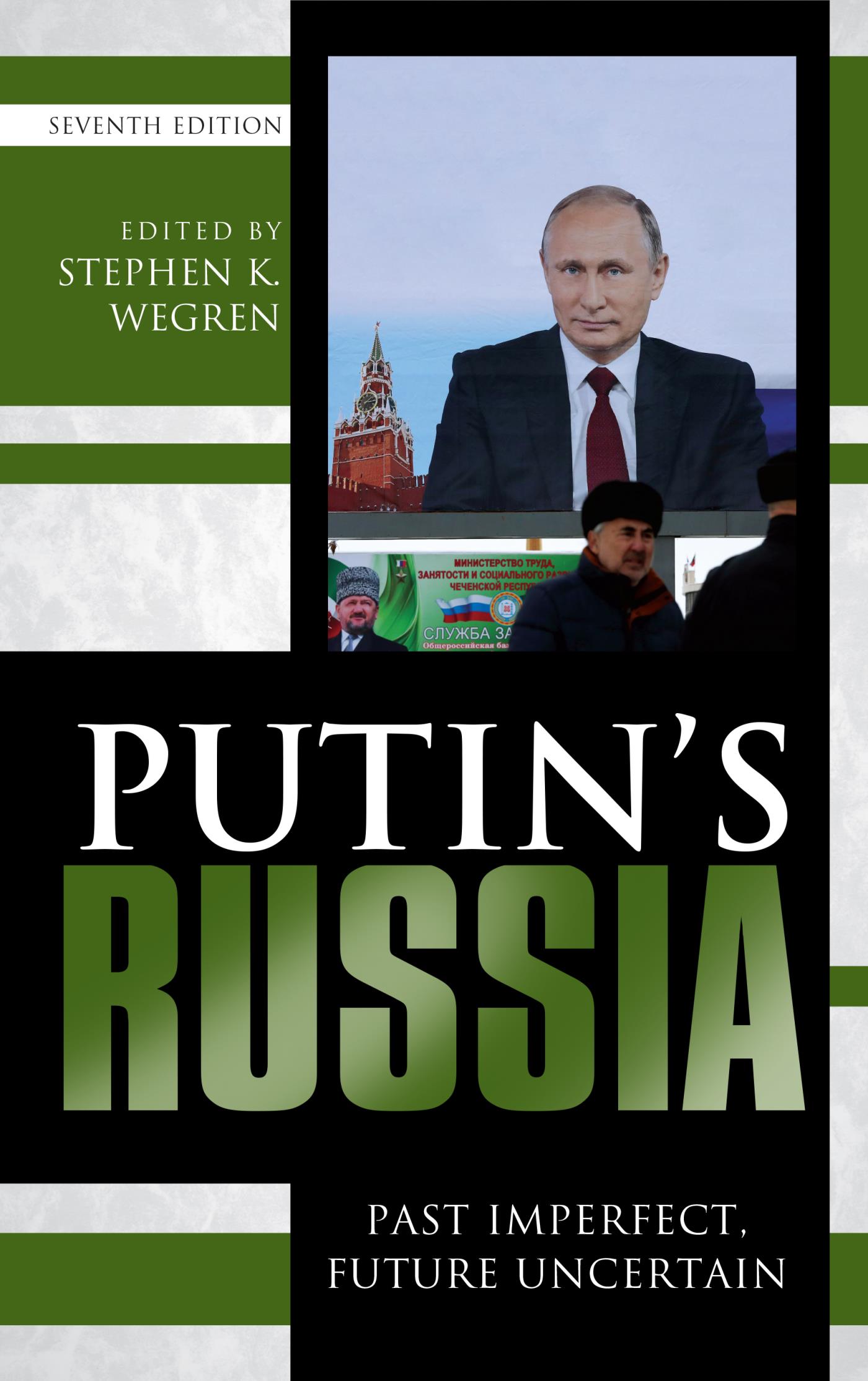
Putin's Russia Now in a thoroughly revised, expanded, and updated edition, this classic text provides an authoritative and current analysis of contemporary Russia. Leading scholars explore the daunting domestic and international problems Russia confronts, considering a comprehensive array of economic, political, foreign policy, and social issues. POLITICAL SCIENCE,World,Russian & Former Soviet Union
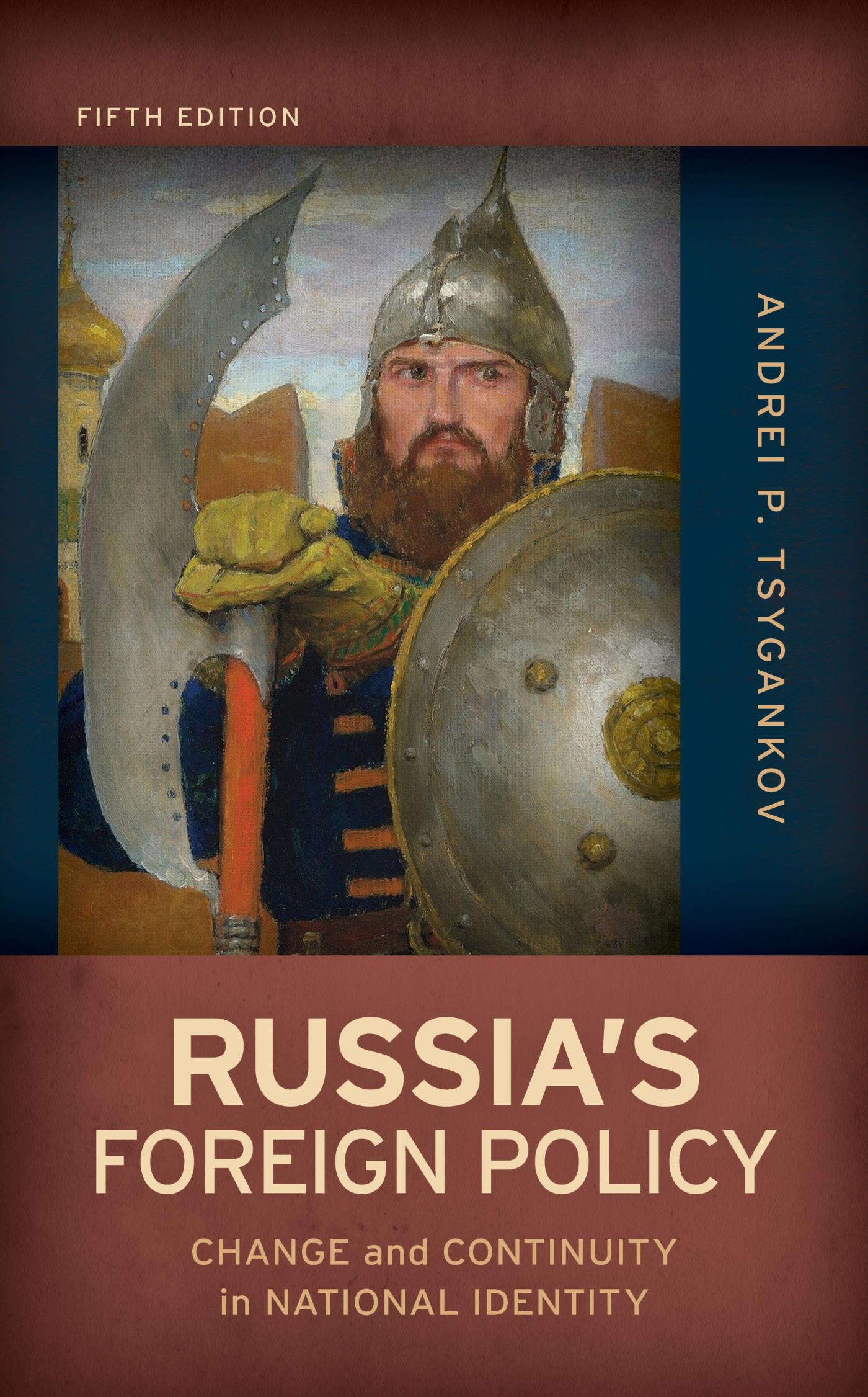
Russia's Foreign Policy Fully updated, this comprehensive text explores Russian international relations, comparing foreign policy formation under Gorbachev, Yeltsin, Medvedev, and Putin. Drawing on an impressive mastery of both Russian and Western sources, Tsygankov shows how Moscow’s policies have shifted with each leader’s vision of Russia’s national interests. POLITICAL SCIENCE,World,Russian & Former Soviet Union
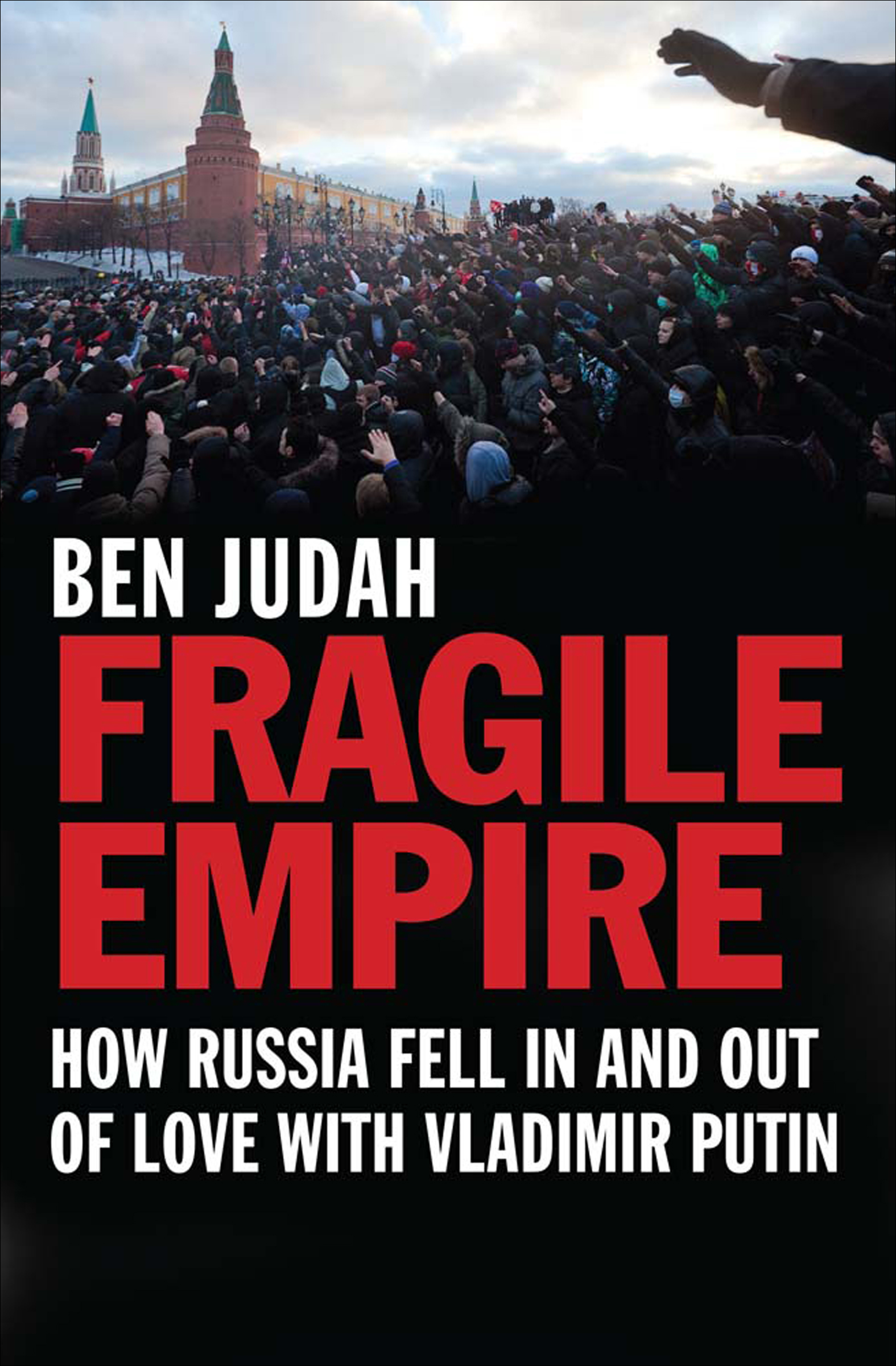
Fragile Empire “A beautifully written and very lively study of Russia that argues that the political order created by Vladimir Putin is stagnating†(Financial Times). From Kaliningrad on the Baltic to the Russian Far East, journalist Ben Judah has traveled throughout Russia and the former Soviet republics, conducting extensive interviews with President Vladimir Putin’s friends, foes, and colleagues, government officials, business tycoons, mobsters, and ordinary Russian citizens. Fragile Empire is the fruit of Judah’s thorough research: A probing assessment of Putin’s rise to power and what it has meant for Russia and her people. Despite a propaganda program intent on maintaining the cliché of stability, Putin’s regime was suddenly confronted in December 2011 by a highly public protest movement that told a different side of the story. Judah argues that Putinism has brought economic growth to Russia but also weaker institutions, and this contradiction leads to instability. The author explores both Putin’s successes and his failed promises, taking into account the impact of a new middle class and a new generation, the Internet, social activism, and globalization on the president’s impending leadership crisis. Can Russia avoid the crisis of Putinism? Judah offers original and up-to-the-minute answers. “[A] dynamic account of the rise (and fall-in-progress) of Russian President Vladimir Putin.†—Publishers Weekly “[Judah] shuttles to and fro across Russia’s vast terrain, finding criminals, liars, fascists and crooked politicians, as well as the occasional saintly figure.†—The Economist “His lively account of his remote adventures forms the most enjoyable part of Fragile Empire, and puts me in mind of Chekhov’s famous 1890 journey to Sakhalin Island.†—The Guardian POLITICAL SCIENCE,World,Russian & Former Soviet Union
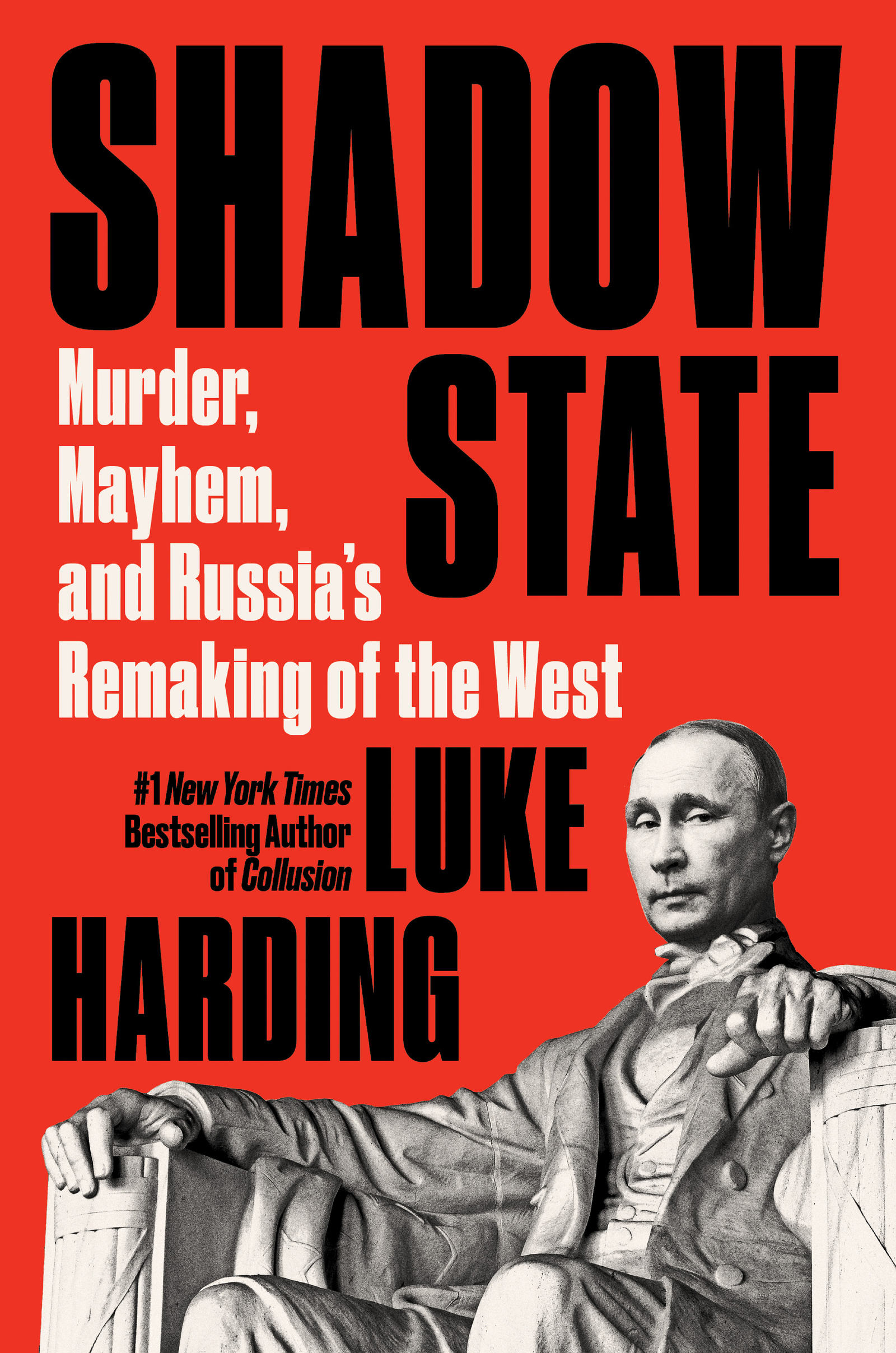
Shadow State A thrilling account of how Russia is waging a hidden war against America and the West, using espionage, corruption, fake news, and KGB-style murder March 2018. Two Russian assassins arrive in a provincial English city to kill a former officer from Russia’s GRU intelligence agency. His crime? Passing secrets to British spies. The poison? A lethal nerve agent, novichok. The attempted execution was a reminder – as if one were needed - of Russia’s contempt for international norms. The Soviet Union and its doctrine are long gone, but the playbook used by the Kremlin’s spies during that long confrontation with the West is back. And the underlying goal remains the same: to undermine democracy and exploit divisions within American and European society and politics. Moscow’s support for Donald Trump in the 2016 presidential election has grown into the biggest political scandal of modern times. Its American players are well-known. In Shadow State, award-winning journalist and bestselling author Luke Harding reveals the Russians behind the story: the spies, hackers and internet trolls. Harding charts how the Kremlin has updated Communist-era methods of influence and propaganda for the age of Facebook and Twitter, and considers the compelling question of our age: what exactly does Vladimir Putin have on President Trump? Similar to those of the Cold War, Putin’s ambitions are truly global. His emissaries include oligarchs, bankers, lawyers, mercenaries, and agents of influence. They roam from Salisbury to Helsinki, Ukraine to Central Africa, London to Washington, D.C. Shadow State is the singular account of how the Kremlin seeks to reshape the world, to divide the US from its European friends, and to remake America in its own dark and kleptocratic image. This is an essential read for anyone who wants to understand how our politics came to be so chaotic and divided. Nothing less than the future of Western democracy is at stake. POLITICAL SCIENCE,World,Russian & Former Soviet Union
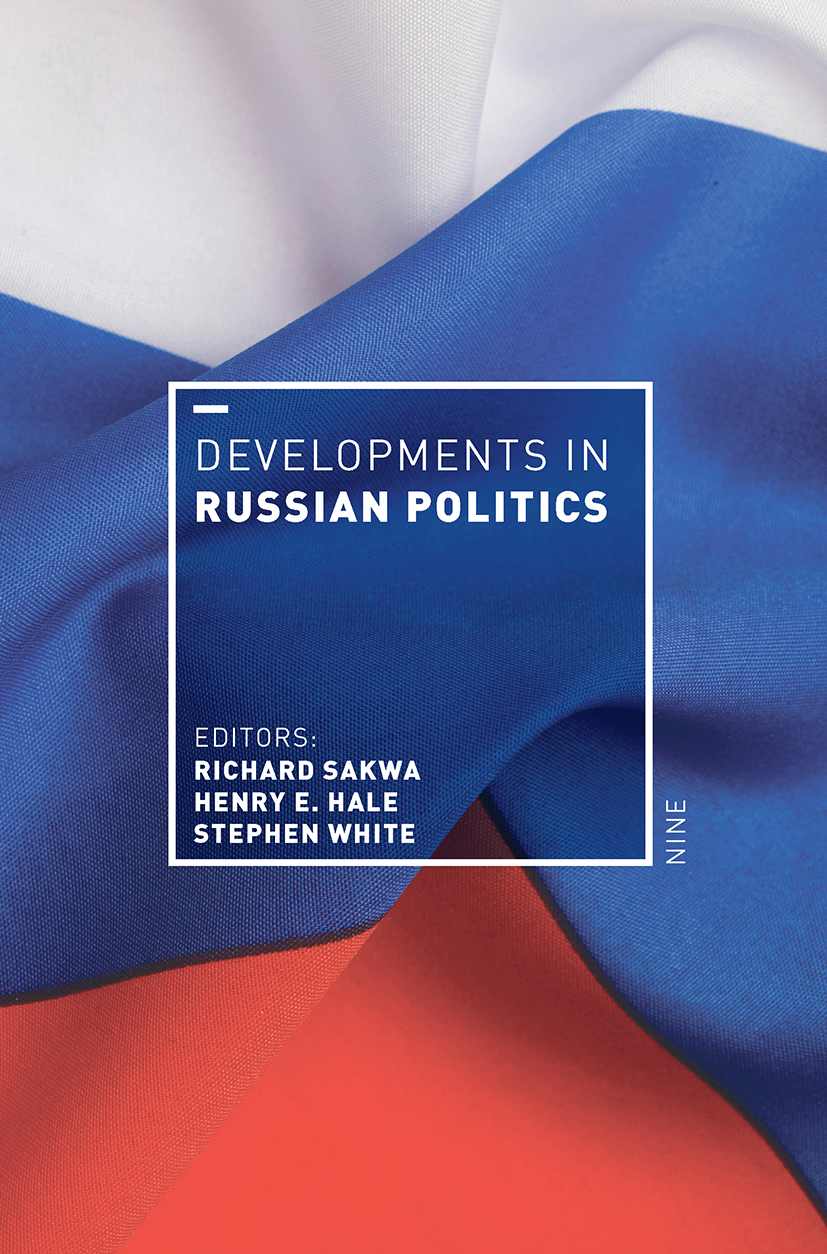
Developments in Russian Politics 9 Developments in Russian Politics 8 brings together a tightly-edited set of specially-commissioned chapters to provide a broad-ranging assessment of Putin's third term in power. Clearly and accessibly written, it will remain the introduction of choice to politics in the world's largest state. POLITICAL SCIENCE,World,Russian & Former Soviet Union
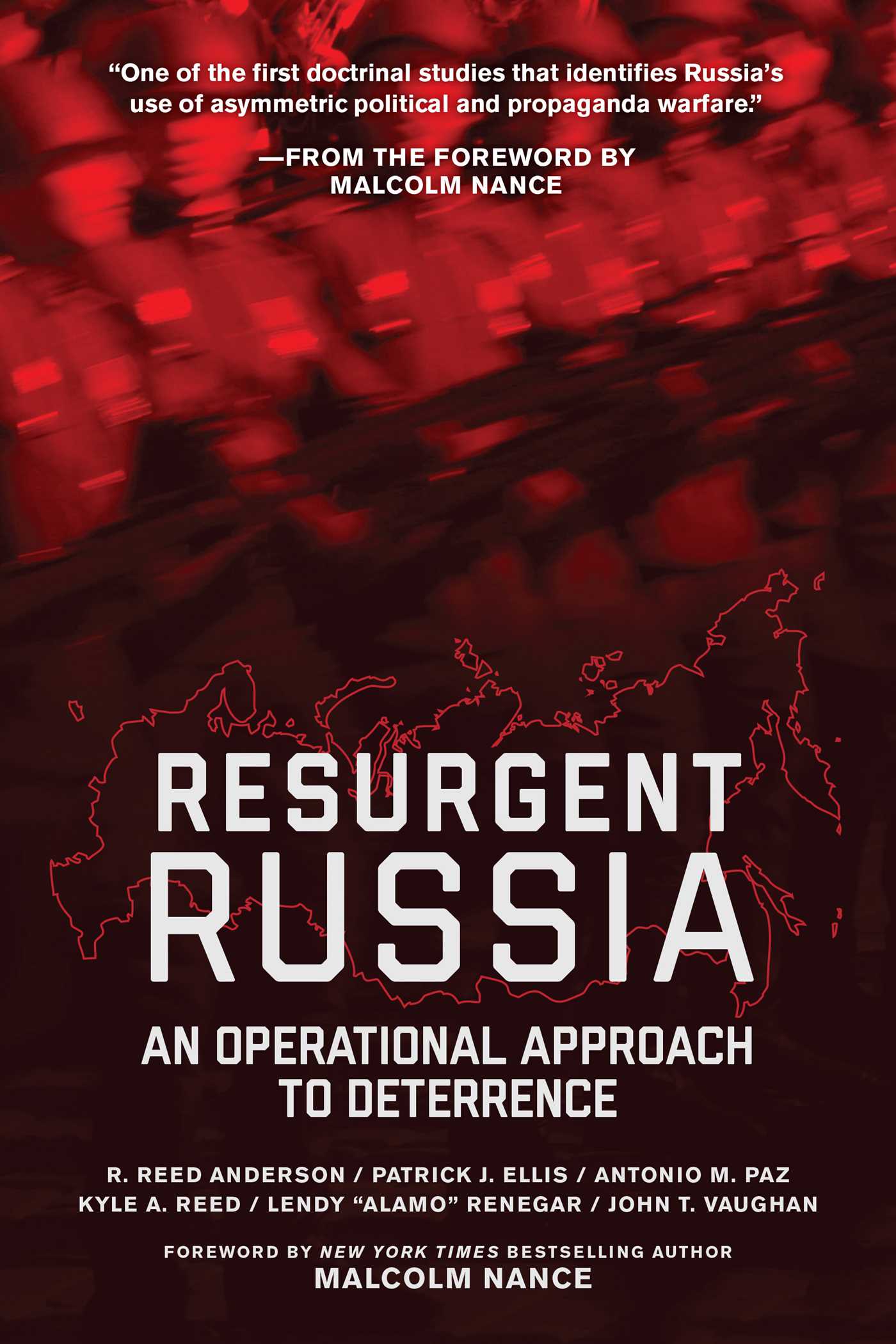
Resurgent Russia Relations between the United States and Russia have recently escalated from strained to outright aggressive. From imperial expansion in Ukraine to intervention in Syria to Russian hacking during the US election in 2016, it is clear that the United States must be prepared to defend itself and its NATO allies against Russian aggression. Resurgent Russia, researched and written by six residents and internationally experienced officers at the US Army War College, analyzes the current threat of Russian acts of war—both conventional military attacks and unconventional cyber warfare or political attacks—against the United Stated and NATO. The officers detail how the America can use its international military resources and political influence to both prepare for and deter aggression ordered by Vladimir Putin, making it clear that such an attack would be unsuccessful and therefore keeping the peace. This study provides a clear assessment of how the United States and its allies must utilize their political and military power to deter Russian aggression and maintain the hierarchy of power in today’s world. POLITICAL SCIENCE,World,Russian & Former Soviet Union

You Can Trust the Communists This book shows that you can trust the Communists to pursue their plan for world domination, but places in your hands the most effective defense weapon there is. Now you can have full knowledge of Communism, learn to understand it, oppose it, and thus bring true freedom to prevail throughout the world. “MUST READINGâ€â€”American Legion Magazine “...should be read by every American, especially by the millions who are unaware of the insidious and subversive tactics employed by our enemy...â€â€”St. Louis Globe-Democrat “Dr. Schwarz’ analysis is both clear and provocative. His book makes for stimulating, and at times even chilling...reading...â€â€”Salt Lake City Deseret News-Telegram “Schwarz does more than point out the danger. He offers a program to battle it...â€â€”Evansville, Indiana Press “...required reading because it can do much to eliminate the confusion that so-called Red double-talk seems to cause...â€â€”Portland, Maine Telegram-Press Herald POLITICAL SCIENCE,World,Russian & Former Soviet Union

The Unfinished Story of Alger Hiss A very interesting investigation authored by a 1950s-era journalist attempting to demonstrate the innocence of Alger Hiss - a former important US State Department official who was accused of communist subversion and espionage on behalf of the Soviet Union. Author insists that the case against Hiss was never adequately proven and that insufficient documentation and testimony was brought forth during the Hiss hearings. Book raises important questions about the flawed nature and questionable proceedings of American justice.-Print ed. POLITICAL SCIENCE,World,Russian & Former Soviet Union
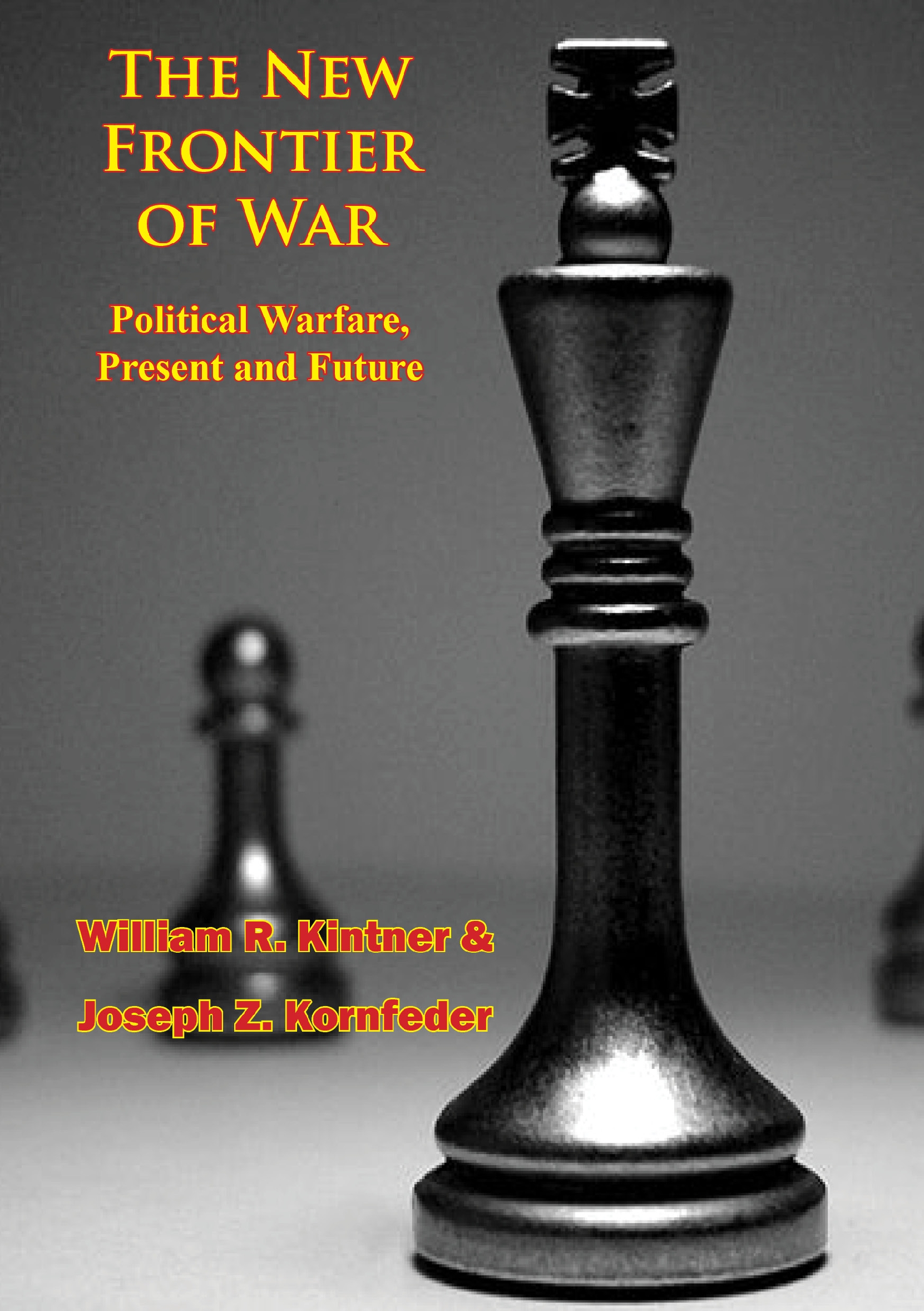
The New Frontier of War This exploration of Soviet communist political maneuvering was written in 1962 at the height of the Cold War by the then professor of Political Science at the University of Pennsylvania and the former leader of the American Communist Party. With examples from recent history the authors show how the inner workings of the Soviet machine differ from the popular idea of how communists proceed. The book also details how the Western World could formulate counter-strategies to the Communist political attacks, assaults and infiltrations. POLITICAL SCIENCE,World,Russian & Former Soviet Union

A World Without Jews The first English translation of Karl Marx’s anti-Semitic writings, with critical analysis by the founder of the Philosophical Library. Long available to the readers of Soviet Russia, here are the unexpurgated papers of Karl Marx on the so-called Jewish question, translated into English by philosopher Dagobert D. Runes. While most of Marx’s anti-Semitic diatribes were carefully eliminated by the translators and editors of his books, journalistic writings, and correspondence, their influence was still considerable. Readers unfamiliar with this aspect of Marx’s thought will be startled to discover how well it has served the purposes of the totalitarian regimes of our time. Runes presents this accurate and unflinching translation with the conviction that any student of Marx should be aware of this aspect of his thought. Extensive comments and critical annotations related to the material appear throughout the book. POLITICAL SCIENCE,World,Russian & Former Soviet Union

Dancing Around the Volcano Celebrating the ingenuity with which gay men manage their sexual and aggressives drives and fantasies, Dancing Around the Volcano is a passionately pro-sex book with potentially healing--even revolutionary--implications for everyone. Kettelhack wants to "tell the truth about the sex gay men are really having"--offering a path to sexual liberation that embraces the conflicts and paradoxes of sex. PSYCHOLOGY,Human Sexuality (see also SOCIAL SCIENCE,Human Sexuality)

Sex at Dawn “Sex at Dawn challenges conventional wisdom about sex in a big way. By examining the prehistoric origins of human sexual behavior the authors are able to expose the fallacies and weaknesses of standard theories proposed by most experts. This is a provocative, entertaining, and pioneering book. I learned a lot from it and recommend it highly.†— Andrew Weil, M.D. “Sex at Dawn irrefutably shows that what is obvious—that human beings, both male and female, are lustful—is true, and has always been so…. The more dubious its evidentiary basis and lack of connection with current reality, the more ardently the scientific inevitability of monogamy is maintained—even as it falls away around us.†— Stanton Peele, Ph.D. A controversial, idea-driven book that challenges everything you (think you) know about sex, monogamy, marriage, and family. In the words of Steve Taylor (The Fall, Waking From Sleep), Sex at Dawn is “a wonderfully provocative and well-written book which completely re-evaluates human sexual behavior and gets to the root of many of our social and psychological ills.†PSYCHOLOGY,Human Sexuality (see also SOCIAL SCIENCE,Human Sexuality)

A Billion Wicked Thoughts Two maverick neuroscientists use the world's largest psychology experiment-the Internet-to study the private activities of millions of men and women around the world, unveiling a revolutionary and shocking new vision of human desire that overturns conventional thinking. For his groundbreaking sexual research, Alfred Kinsey and his team interviewed 18,000 people, relying on them to honestly report their most intimate experiences. Using the Internet, the neuroscientists Ogas and Gaddam quietly observed the raw sexual behaviors of half a billion people. By combining their observations with neuroscience and animal research, these two young neuroscientists finally answer the long-disputed question: what do people really like? Ogas and Gaddam's findings are transforming the way scientists and therapists think about sexual desire. In their startling book, Ogas and Gaddam analyze a "billion wicked thoughts" on the Internet: a billion Web searches, a million individual search histories, a million erotic stories, a half-million erotic videos, a million Web sites, millions of online personal ads, and many other enormous sources of sexual data in order to understand the true differences between male and female desires, including: ?Men and women have hardwired sexual cues analogous to our hardwired tastes-there are sexual versions of sweet, sour, salty, savory, and bitter. But men and women are wired with different sets of cues. ?The male sexual brain resembles a reckless hunter, while the female sexual brain resembles a cautious detective agency. ?Men form their sexual interests during adolescence and rarely change. Women's sexual interests are plastic and change frequently. ?The male sexual brain is an "or gate": A single stimulus can arouse it. The female sexual brain is an "and gate": It requires many simultaneous stimuli to arouse it. ?When it comes to sexual arousal, men prefer overweight women to underweight women, and a significant number of men seek out erotic images of women in their 40s, 50s, and 60s. ?Women enjoy writing and sharing erotic stories with other women. The fastest growing genre of erotic stories for women are stories about two heterosexual men having sex. ?Though the male sexual brain is much more different from the female sexual brain than is commonly believed, the sexual brain of gay men is virtually identical to that of straight men. Featuring cutting-edge, jaw-dropping science, this wildly entertaining and controversial book helps readers understand their partner's sexual desires with a depth of knowledge unavailable from any other source. Its fascinating and occasionally disturbing findings will rock our modern understanding of sexuality, just as Kinsey's reports did sixty years ago. PSYCHOLOGY,Human Sexuality (see also SOCIAL SCIENCE,Human Sexuality)

The Chemistry Between Us How much control do we have over love? Much less than we like to think. All that mystery, all that poetry, all those complex behaviors surrounding human bonding leading to the most life-changing decisions we’ll ever make, are unconsciously driven by a few molecules in our brains. How does love begin? How can two strangers come to the conclusion that it would not only be pleasant to share their lives, but that they must share them? How can a man say he loves his wife, yet still cheat on her? Why do others stay in relationships even after the romance fades? How is it possible to fall in love with the “wrong” person? How do people come to have a “type”? Physical attraction, jealousy, infidelity, mother-infant bonding—all the behaviors that so often leave us befuddled—are now being teased out of the fog of mystery thanks to today’s social neuroscience. Larry Young, one of the world’s leading experts in the field, and journalist Brian Alexander explain how those findings apply to you. Drawing on real human stories and research from labs around the world, The Chemistry Between Us is a bold attempt to create a “grand unified theory” of love. Some of the mind-blowing insights include: Love can get such a grip on us because it is, literally, an addiction. To a woman falling in love, a man is like her baby. Why it’s false to say society makes gender, and how it’s possible to have the body of one gender and the brain of another. Why some people are more likely to cheat than others. Why we sometimes truly can’t resist temptation. Young and Alexander place their revelations into historical, political, and social contexts. In the process, they touch on everything from gay marriage to why single-mother households might not be good for society. The Chemistry Between Us offers powerful insights into love, sex, gender, sexual orientation, and family life that will prove to be enlightening, controversial, and thought provoking. PSYCHOLOGY,Human Sexuality (see also SOCIAL SCIENCE,Human Sexuality)

Children of the Future Translated by Derek and Inge Jordan In Children of the Future, Wilhelm Reich shows how disastrous the exclusion of genitality is to the young and its important influence on their development. In his 1932 work The Sexual Rights of Youth, published here in its revised form, Reich speaks in terms of what he sees as the real meaning of the sexual enlightenment of youth: it is not the mystery and dangers of procreation, but the essential nature of sexuality and the right of youth to genital gratification. Reich presents a new way of seeing the parental compulsion to teach. In other chapters, Reich examines attitudes toward infantile masturbation, the source of the human no, and special disturbances of the young. Reichs work is substantiated by his concrete observations and experiences with children, including case studies from the Orgonomic Infant Research Center. PSYCHOLOGY,Human Sexuality (see also SOCIAL SCIENCE,Human Sexuality)

Sexual Mutilations Proceedings of the Fourth International Symposium held in Lausanne, Switzerland, August 9-11, 1996 PSYCHOLOGY,Human Sexuality (see also SOCIAL SCIENCE,Human Sexuality)

Is My Husband Gay, Straight, or Bi? Is My Husband Gay, Straight, or Bi? addresses a topic that many people may have experience with, but don’t know where to go to find the answers. At a time when the definition of marriage is changing, and relationships in general may be fraught with uncertainty about a variety of basic issues, a book that addresses the concerns of women who suspect their men are gay or have gay tendencies can help make sense of a confusing situation and reveal ways in which couples can understand a man’s interest in gay sex and remain married, even happily. PSYCHOLOGY,Human Sexuality (see also SOCIAL SCIENCE,Human Sexuality)

A Sexual Odyssey The Brave New World of Sex We've seen in less than a generation a swift revolution in human sexual behavior, attitude, and consequences so dramatic that some people are left in a state of stunned dismay and the public at large in aimless confusion. Much of the trend, if you can call a revolu tion a trend, is fueled by, or at least made possible by, technological innovations dating back to the middle of the twentieth century. The birth control pill opened the gate to promiscuity with little fear of pregnancy; marriage became an annoyance; divorce be came an opportunity; two working parents became a necessity; and teenage sex became nearly as socially acceptable as holding hands or going to the movies. The copulation explosion resulted in a spiraling epidemic of children giving birth to children, many of them on welfare. Girls seeking relief through abortions were sometimes forced to have their unwanted offspring despite the inevitability of some of them living in poverty and a desperate dead-end environment of squalor and crime. Some misguidedly wanted babies and ended up the same way. To top it all, discipline 2 A Sexual Odyssey became a lost art, leaving schools and neighborhoods infested with gun-toting, knife-wielding teenage delinquents-even in middle-class areas-who engaged in contests fo see who could get the most girls knocked up. The chaotic state of fornication, mating, and birthing may be a throwback to the past. PSYCHOLOGY,Human Sexuality (see also SOCIAL SCIENCE,Human Sexuality)

HIV-Negative PSYCHOLOGY,Human Sexuality (see also SOCIAL SCIENCE,Human Sexuality)

Three Essays on the Theory of Sexuality The first edition of this classic work from 1905 shows a radically different psychoanalysis Available for the first time in English, the 1905 edition of Three Essays on the Theory of Sexuality presents Sigmund Freud’s thought in a form new to all but a few ardent students of his work. This is a Freud absent the Oedipal complex, which came to dominate his ideas and subsequent editions of these essays. In its stead is an autoerotic theory of sexual development, a sexuality transcending binary categorization. This is psychoanalysis freed from ideas that have often brought it into conflict with the ethical and political convictions of modern readers, practitioners, and theorists. The non-Oedipal psychoanalysis Freud outlined in 1905 possesses an emancipatory potential for the contemporary world that promises to revitalize Freudian thought. The development of self is no longer rooted in the assumption of a sexual identity; instead the imposition of sexual categories on the infant mind becomes a source of neurosis and itself a problem to overcome. The new edition of Three Essays presents us with the fascinating possibility that Freud suppressed his first and best thoughts on this topic, and that only today can they be recognized and understood at a time when societies have begun the serious work of reconceptualizing sexual identities. PSYCHOLOGY,Human Sexuality (see also SOCIAL SCIENCE,Human Sexuality)

Lesbian Love Addiction People in any type of relationship may find themselves addicted to a cycle of self-destructive behaviors. Looking at lesbian relationships, Costine explores how these behaviors result in unhappiness and loneliness, as she discusses different types of lesbian love addiction and offers guidance on healing and breaking the cycle. PSYCHOLOGY,Human Sexuality (see also SOCIAL SCIENCE,Human Sexuality)

The State of Affairs Iconic couples’ therapist and bestselling author of Mating in Captivity Esther Perel returns with a provocative look at relationships through the lens of infidelity. An affair: it can rob a couple of their relationship, their happiness, their very identity. And yet, this extremely common human experience is so poorly understood. What are we to make of this time-honored taboo—universally forbidden yet universally practiced? Why do people cheat—even those in happy marriages? Why does an affair hurt so much? When we say infidelity, what exactly do we mean? Do our romantic expectations of marriage set us up for betrayal? Is there such a thing as an affair-proof marriage? Is it possible to love more than one person at once? Can an affair ever help a marriage? Perel weaves real-life case stories with incisive psychological and cultural analysis in this fast-paced and compelling book. For the past ten years, Perel has traveled the globe and worked with hundreds of couples who have grappled with infidelity. Betrayal hurts, she writes, but it can be healed. An affair can even be the doorway to a new marriage—with the same person. With the right approach, couples can grow and learn from these tumultuous experiences, together or apart. Affairs, she argues, have a lot to teach us about modern relationships—what we expect, what we think we want, and what we feel entitled to. They offer a unique window into our personal and cultural attitudes about love, lust, and commitment. Through examining illicit love from multiple angles, Perel invites readers into an honest, enlightened, and entertaining exploration of modern marriage in its many variations.Fiercely intelligent, The State of Affairs provides a daring framework for understanding the intricacies of love and desire. As Perel observes, “Love is messy; infidelity more so. But it is also a window, like no other, into the crevices of the human heart.†PSYCHOLOGY,Human Sexuality (see also SOCIAL SCIENCE,Human Sexuality)

The Complete Illustrated Kama Sutra A fully illustrated Kama Sutra from the extraordinary and rare art collection of Lance Dane • The first complete translation to illustrate all 64 sexual postures described in the Kama Sutra • Includes 269 rare images • Composed by one of the world’s foremost scholars of the Kama Sutra and Indian art The erotic sentiments described in the Hindu love classic the Kama Sutra constitute the most famous work on sex ever created. Written almost 2,000 years ago, the Kama Sutra deals with all aspects of sexual life, including the principles and techniques of sexual pleasure and how to best achieve ecstatic expression of life’s beauty. In this complete and illustrated guide Lance Dane accompanies the Kama Sutra text with 269 illustrations and great works of art that encompass coins, palm leaf manuscripts, sculptures, ancient toys, jewelry, architecture, ivory combs, birch bark, cloth, paintings, frescoes, and scrolls. Gathered from museums and private collections around the world—as well as the author’s own collection of over 300,000 photographs—these rare images clearly illustrate all 64 sexual positions and the erotic instructions set forth in the Kama Sutra. The result is a dazzling and sensuous reading experience through which the teachings of the Kama Sutra spring to life. PSYCHOLOGY,Human Sexuality (see also SOCIAL SCIENCE,Human Sexuality)

Sacred Sexuality A historical, cross-cultural survey of sexuality as a sacred spiritual practice • Examines sacred sexuality in the world’s religious and mystery traditions • Explores contemporary “sexual stress syndrome†resulting from the absence of the sacred in sexual practice • Reveals how to find the sacred in the ordinary This book examines the history of sexuality as a sacramental act. In spite of our culture’s recent sexual liberalizations, sexual intimacy often remains unfulfilling. Georg Feuerstein instructs that the fulfillment we long for in our sex lives can only be attained once we have explored the spiritual depths of our erotic natures. Feuerstein delves into a wide variety of spiritual traditions--including Christianity, Judaism, goddess worship, Taoism, and Hinduism--in search of sacred truths regarding sexuality. He reveals that all of these great teachings share the hidden message that spirituality is, in essence, erotic and that sexuality is inherently spiritual. From the erotic cult of the Great Mother and the archaic ritual of hieros gamos (sacred marriage) to the institution of sacred prostitution and the erotic spirituality practiced in the mystery traditions, Feuerstein offers a wealth of historical practices and perspectives that serve as the bases for a positive sexual spirituality suited to our contemporary needs. PSYCHOLOGY,Human Sexuality (see also SOCIAL SCIENCE,Human Sexuality)

The Sexual Teachings of the Jade Dragon Reveals how the sexual practices of the Taoist Jade Dragon can help men achieve "immortality" through the enhancement of their sexual prowess. • A companion guide to The Sexual Teachings of the White Tigress that focuses on the male side of White Tigress sexual practices. • Reveals the nine Jade Dragon exercises and other Taoist techniques for achieving the elixir of immortality. • Offers physical and spiritual solutions for the sexual issues facing men. Hsi Lai continues the work he began in The Sexual Teachings of the White Tigress by exploring more fully the male role in Taoist sexual transformation. As with those of the White Tigress, the techniques of the Jade Dragon are part of a disciplined sexual and spiritual practice. The goal for the Jade Dragon is health, longevity, and immortality through external and internal regimens for the enhancement and accumulation of the Three Treasures of Taoism--ching (sexual and physical energy), qi (breath and vital energy) and shen (spiritual and mental energy). The author presents the nine Jade Dragon exercises that strengthen erections, enlarge the penis, increase semen quantity and quality, prevent premature ejaculations, and enhance sexual energy. He also details herbal remedies for revitalization that address both physical and spiritual sexual components, as well as ancient Taoist breathing and meditative practices and sexual stimulation techniques that amplify sexual intensity in order to create the elixir of immortality. Concluding with the importance of the interactions between and interdependence of White Tigresses and Jade Dragons, Hsi Lai shows the reader how these ancient Taoist secrets can be incorporated into a contemporary lifestyle. PSYCHOLOGY,Human Sexuality (see also SOCIAL SCIENCE,Human Sexuality)

The Psychology of Human Sexuality New edition of an authoritative guide to human sexual behavior from a biopsychosocial perspective The thoroughly revised and updated second edition of The Psychology of Human Sexuality explores the roles that biology, psychology, and the social and cultural context play in shaping human sexual behavior. The author – a noted authority on the topic and an affiliate of the acclaimed Kinsey Institute - puts the spotlight on the most recent research and theory on human sexuality, with an emphasis on psychology. The text presents the major theoretical perspectives on human sexuality, and details the vast diversity of sexual attitudes and behaviors that exist in the modern world. The author also reviews the history of sexology and explores its unique methods and ethical considerations. Overall, this important and comprehensive text provides readers with a better understanding of, and appreciation for, the science of sex and the amazing complexity of human sexuality. Features broad coverage of topics including anatomy, gender and sexual orientation, sexual behaviors, sexual difficulties and solutions, prostitution, and pornography Offers more in-depth treatment of relationships than comparable texts, with separate chapters dealing with attraction and relationship processes Includes cutting-edge research on the origins of sexual orientation and gender identity, as well as new treatments for sexually transmitted infections and sexual dysfunctions Is written from a sex-positive perspective, with expanded coverage of cross-cultural research throughout and material that is inclusive and respectful of a diverse audience Includes numerous activities to facilitate dynamic, interactive classroom environments Written for students of human sexuality and anyone interested in the topic, The Psychology of Human Sexuality offers a guide to the psychology of human sexual behavior that is at once inclusive, thorough, and authoritative in its approach. PSYCHOLOGY,Human Sexuality (see also SOCIAL SCIENCE,Human Sexuality)

Tell Me What You Want A leading expert on human sexuality and author of the blog Sex and Psychology offers an unprecedented look at sexual fantasy based on the most comprehensive, scientific survey ever undertaken. What do Americans really want when it comes to sex? And is it possible for us to get what we want? Justin J. Lehmiller, one of the country's leading experts on human sexuality and author of the popular blog Sex and Psychology, has made it his career's ambition to answer these questions. He recently concluded the largest and most comprehensive scientific survey of Americans' sexual fantasies ever undertaken, a monumental two-year study involving more than 4,000 Americans from all walks of life, answering questions of unusual scope. Based on this study, Tell Me What You Want offers an unprecedented look into our fantasy worlds and what they reveal about us. It helps readers to better understand their own sexual desires and how to attain them within their relationships, but also to appreciate why the desires of their partners may be so incredibly different. If we only better understood the incredible diversity of human sexual desire and why this diversity exists in the first place, we would experience less distress, anxiety, and shame about our own sexual fantasies and better understand why our partners often have sexual proclivities that are so different from our own. Ultimately, this book will help readers to enhance their sex lives and to maintain more satisfying relationships and marriages in the future by breaking down barriers to discussing sexual fantasies and allowing them to become a part of readers' sexual realities. PSYCHOLOGY,Human Sexuality (see also SOCIAL SCIENCE,Human Sexuality)

Untrue From the #1 New York Times bestselling author of Primates of Park Avenue, a bold, timely reconsideration of female infidelity that will upend everything you thought you knew about women and sex. What do straight, married female revelers at an all-women's sex club in LA have in common with nomadic pastoralists in Namibia who bear children by men not their husbands? Like women worldwide, they crave sexual variety, novelty, and excitement. In ancient Greek tragedies, Netflix series, tabloids and pop songs, we've long portrayed such cheating women as dangerous and damaged. We love to hate women who are untrue. But who are they really? And why, in this age of female empowerment, do we continue to judge them so harshly? In Untrue, feminist author and cultural critic Wednesday Martin takes us on a bold, fascinating journey to reveal the unexpected evolutionary legacy and social realities that drive female faithlessness, while laying bare our motivations to contain women who step out. Blending accessible social science and interviews with sex researchers, anthropologists, and real women from all walks of life, Untrue challenges our deepest assumptions about ourselves, monogamy, and the women we think we know. From recent data suggesting women may struggle more than men with sexual exclusivity to the revolutionary idea that females of many species evolved to be "promiscuous" to Martin's trenchant assertion that female sexual autonomy is the ultimate metric of gender equality, Untrue will change the way you think about women and sex forever. PSYCHOLOGY,Human Sexuality (see also SOCIAL SCIENCE,Human Sexuality)

Principles and Practice of Sex Therapy, Fifth Edition The leading clinical reference and text in the field, originally developed by the late Sandra Leiblum, this volume addresses the full range of sexual problems and concerns that lead men, women, and couples to seek help. Prominent experts describe cutting-edge assessment and treatment approaches that draw on psychological, interpersonal, and medical interventions. Detailed case examples illustrate how the therapeutic strategies are implemented and shed light on the factors that influence outcomes. The book is grounded in current knowledge about sexuality and sexual functioning across the lifespan. Tightly edited, it features an integrative introduction and conclusion plus a brief editorial commentary at the beginning of each chapter. New to This Edition*Reflects major advances in sexual medicine and changes in the DSM-5.*Chapters on infidelity, body image, and noncoercive and coercive paraphilias.*Chapters on sexuality and infertility, disability-affirmative therapy, and sexually transmitted infections.*Expanded lifespan focus: chapters on adolescents/young adults and older adults.*Many new authors and extensively revised chapters. PSYCHOLOGY,Human Sexuality (see also SOCIAL SCIENCE,Human Sexuality)

The New Injection Treatment For Impotence In this volume, two experts on sexual disorders describe the most effective treatment yet developed for male impotence. The authors review both the medical and the psychiatric aspects of injection treatment for men of all ages, with particular attention to older men and those with psychogenic impotence. The authors also discuss ethical considerations. PSYCHOLOGY,Human Sexuality (see also SOCIAL SCIENCE,Human Sexuality)

Rekindling Desire For over a decade, Rekindling Desire has helped to restore and affirm pleasure-oriented sexuality for thousands of people. Drawing on respected therapist Barry McCarthy’s extensive knowledge and experience, this updated third edition offers strategies and solutions for no-sex relationships and low sexual desire. Contained within are psychosocial sexual skill exercises that will develop communication and confidence, as well as fascinating case studies that illustrate a wide range of couples’ sexual frustrations. The shame, embarrassment, and hesitancy that individuals feel with themselves, and the resentment and blame they can feel towards their sexual partners, are explored and put into context. With an individualized relapse prevention plan to ensure sexual gains are maintained and built upon, the book encourages couples to work as a team to minimize guilt and maximize intimacy. Rekindling Desire, 3rd edition fully celebrates female and male sexuality, challenges inhibitions and avoidance, and promotes satisfying, secure, and sexual relationships. Whether you are married, cohabitating, or dating, it will help renew sexual desire and empower people of all sexual orientations and ages on the path towards healthy, pleasure-oriented sexuality. PSYCHOLOGY,Human Sexuality (see also SOCIAL SCIENCE,Human Sexuality)

Sex and Belonging In this stunning new work, Tony Schneider, a practising clinical psychologist for over 30 years, outlines a new model of psychological drives around sexual behaviour. He describes a dual biological and subjective, multiple-drive profile, that energises and directs individual sexual behaviour. The book takes a middle path between the determinist thinking that frequently underpins scientific psychological research, and the psychodynamic theory often used by clinicians. PSYCHOLOGY,Human Sexuality (see also SOCIAL SCIENCE,Human Sexuality)

The Voyeur's Motel The controversial chronicle of a motel owner who secretly studied the sex lives of his guests by the renowned journalist and author of Thy Neighbor’s Wife. On January 7, 1980, in the run-up to the publication of his landmark bestseller Thy Neighbor’s Wife, Gay Talese received an anonymous letter from a man in Colorado. “Since learning of your long-awaited study of coast-to-coast sex in America,†the letter began, “I feel I have important information that I could contribute to its contents or to contents of a future book.†The man—Gerald Foos—hen divulged an astonishing secret: he had bought a motel outside Denver for the express purpose of satisfying his voyeuristic desires. Underneath its peaked roof, he had built an “observation platform†through which he could peer down on his unwitting guests. Over the years, Foos sent Talese hundreds of pages of notes on his guests, work that Foos believed made him a pioneering researcher into American society and sexuality. Through his Voyeur’s motel, he witnessed and recorded the harsh effects of the war in Vietnam, the upheaval in gender roles, the decline of segregation, and much more. In The Voyeur’s Motel. “the reader observes Talese observing Foos observing his guests.†An extraordinary work of narrative journalism, it is at once an examination of one unsettling man and a portrait of the secret life of the American heartland over the latter half of the twentieth century (Daily Mail, UK). “This is a weird book about weird people doing weird things, and I wouldn’t have put it down if the house were on fire.†—John Greenya, Washington Times PSYCHOLOGY,Human Sexuality (see also SOCIAL SCIENCE,Human Sexuality)

Love Deformed, Love Transformed How is human love deformed in sexual addiction? How can human love be transformed? David Bellusci considers three signs of addiction and then, by looking at neurotic tendencies within a psychoanalytical framework, as well as the neurobiological nature of sexual pleasure, explores the causes of sexual addiction. Behavioral expression of addiction is examined in pornography, masturbation, cybersex, and multiple sexual partners. Working within a Christian anthropology drawn from Thomas Aquinas, Bellusci considers the morality of pleasure; how pleasure suggests an antinomy of satisfaction-dissatisfaction. He explores how the fallen human condition effects the will, and the consent to sin. He concludes with a focus on how the addict may be supported, at the psychological, relational, and spiritual levels. PSYCHOLOGY,Human Sexuality (see also SOCIAL SCIENCE,Human Sexuality)

Women Who Sell Sex Based on leading empirical psychological research from around the world, this book offers valuable insights on women who sell sex. It synthesizes the extensive body of scholarly work on the topic of women selling sex from a psychological perspective in order to understand why women choose to do so. In turn, the book highlights a range of important sociocultural contexts surrounding the sale of sex that are major sources of stress, and examines how women cope with these circumstances. Illustrating the multi-faceted nature of selling sex, the book will contribute to debates on individual and societal responses to this major sociopolitical—and at the same time, deeply personal—issue. Including original case material and outlining future directions for researchers, it offers an informative and engaging resource for academics, researchers, students and professionals around the globe. PSYCHOLOGY,Human Sexuality (see also SOCIAL SCIENCE,Human Sexuality)

Sex ... Naturally! In this work, among others, you will know: How to make organic sex toys.How to get the most out of tantric sex.Kama-Sutra for Westerners. Food and meals to enhance sexual desire. Male and female masturbation techniques. Gym-sex, gymnastics to enhance sexuality. How to avoid STDs.Keys to understanding sex in all ages. “Javier Ajerman has known how to include in Sex … Naturally!†all the components that make this work a practical, entertaining manual full of advice that will delight the reader, in the literal sense of the word. It has surprised me, I assure you, at the same time that it has made me smile in many chapters, because sex and laughter are, in the author’s words “a sure path to shared happiness.†Said Silvia Fominaya on the prologue. PSYCHOLOGY,Human Sexuality (see also SOCIAL SCIENCE,Human Sexuality)

LGBTQ Clients in Therapy All the answers clinicians need to work effectively with LGBTQ clients. A therapist who treats LGBTQ clients often must be more than “gay friendly.†Clinical experience, scientific research, and cultural understanding are advancing rapidly, and the task of being LGBTQ informed is ever-changing in today's world. This book covers topics such as how to avoid making the common mistake of believing that "a couple is a couple," thus treating LGBTQ couples the same as their heterosexual counterparts; how to treat clients struggling in "mixed" orientation marriages and relationships (straight and LGBTQ spouses in the same couple); and how to work with all clients who have non-heteronormative sexual behaviors and practices. Perhaps most importantly, the book discusses covert cultural sexual abuse (the trauma suffered from having to suppress one's own sexual and gender identity) as well as the difficult process of coming out to family and friends. A therapist's job is to help clients and their identities through their own lens and not anyone else's—especially the therapist's. The gay affirmative principles put forward in this book will help you build a stronger relationship with your LGBTQ clients and become the go-to therapist in your area. PSYCHOLOGY,Human Sexuality (see also SOCIAL SCIENCE,Human Sexuality)

Queering Law and Order In Queering Law and Order , Kevin Leo Yabut Nadal examines the state of LGBTQ people within the criminal justice system, through legal cases, academic research, and popular media. This book serves as both an academic resource and a call to action for scholars, researchers, and students interested in advocating for LGBTQ rights. PSYCHOLOGY,Human Sexuality (see also SOCIAL SCIENCE,Human Sexuality)

This Is Your Brain on Music In this groundbreaking union of art and science, rocker-turned-neuroscientist Daniel J. Levitin explores the connection between music—its performance, its composition, how we listen to it, why we enjoy it—and the human brain. Taking on prominent thinkers who argue that music is nothing more than an evolutionary accident, Levitin poses that music is fundamental to our species, perhaps even more so than language. Drawing on the latest research and on musical examples ranging from Mozart to Duke Ellington to Van Halen, he reveals: • How composers produce some of the most pleasurable effects of listening to music by exploiting the way our brains make sense of the world• Why we are so emotionally attached to the music we listened to as teenagers, whether it was Fleetwood Mac, U2, or Dr. Dre• That practice, rather than talent, is the driving force behind musical expertise• How those insidious little jingles (called earworms) get stuck in our head A Los Angeles Times Book Award finalist, This Is Your Brain on Music will attract readers of Oliver Sacks and David Byrne, as it is an unprecedented, eye-opening investigation into an obsession at the heart of human nature. SCIENCE,Acoustics & Sound

How Music Works What makes a musical note different from any other sound? How can you tell if you have perfect pitch? Why do 10 violins sound only twice as loud as one? Do your Bob Dylan albums sound better on CD or vinyl? John Powell, a scientist and musician, answers these questions and many more in How Music Works, an intriguing and original guide to acoustics. In a clear, accessible, and engaging voice, Powell fascinates the reader with his delightful descriptions of the science and psychology lurking beneath the surface of music. With lively discussions of the secrets behind harmony, timbre, keys, chords, loudness, musical composition, and more, How Music Works will be treasured by music lovers everywhere. The book also includes a CD of examples and exercises from the book. SCIENCE,Acoustics & Sound

Principles of Vibration and Sound The first edition of this book presented the principles of vibration and sound with only a little discussion of applications of these principles. During the past eight years, our own experience, as well as that of other teachers who used it as a textbook, has indicated that students would benefit from more discussion of applications. In this edition we have revised some of the mate rial in the first nine chapters, but more importantly we have added four new chapters dealing with applications, including microphones, loudspeakers, and other transducers; acoustics of concert halls and studios; sound and noise outdoors; and underwater sound. Of course we could have selected many additional applications of vibration and sound, but that would have led to a book with too much material for the average acoustics course in physics and engineering departments. We think there is now ample material in the book so that instructors may select the applications of particular in terest and omit the others without loss of continuity. We have continued to stress concepts over detailed theory, as seems most appropriate for an in troductory course. We appreciate the comments we have received from users, students, and teachers alike, and we continue to welcome feedback. September 2003 Thomas D. Rossing Neville H. Fletcher Preface to the First Edition Some years ago we set out to write a detailed book about the basic physics of musical instruments. SCIENCE,Acoustics & Sound

Singularities and Oscillations This IMA Volume in Mathematics and its Applications SINGULARITIES AND OSCILLATIONS is based on the proceedings of a very successful one-week workshop with the same title, which was an integral part of the 1994-1995 IMA program on "Waves and Scattering. " We would like to thank Joseph Keller, Jeffrey Rauch, and Michael Taylor for their excellent work as organizers of the meeting. We would like to express our further gratitude to Rauch and Taylor, who served as editors of the proceedings. We also take this opportunity to thank the National Science Foun dation (NSF), the Army Research Office (ARO) and the Office of Naval Research (ONR), whose financial support made the workshop possible. Avner Friedman Robert Gulliver v PREFACE Thestudyofsingularitiesand oscillationsofwaves has progressed along several fronts. A key common feature is the presence of a small scale in the solutions. Recent emphasis has been on nonlinear waves. Nonlinear problems are generally less amenable than linear problems to broad unified approaches. As a result there is a justifiable tendency to concentrate on problems of particular geometric or physical interest. This volume con tains a multiplicity of approaches brought to bear on problems varying from the formation ofcaustics and the propagation ofwaves at a boundary to the examination ofviscous boundary layers. There is an examination of the foundations of the theory of high-frequency electromagnetic waves in a dielectric or semiconducting medium. Unifying themes are not entirely absent from nonlinear analysis. SCIENCE,Acoustics & Sound

Digital Signal Processing for Communication Systems Digital Signal Processing for Communication Systems examines the plans for the future and the progress that has already been made, in the field of DSP and its applications to communication systems. The book pursues the progression from communication and information theory through to the implementation, evaluation and performance enhancing of practical communication systems using DSP technology. Digital Signal Processing for Communication Systems looks at various types of coding and modulation techniques, describing different applications of Turbo-Codes, BCH codes and general block codes, pulse modulations, and combined modulation and coding in order to improve the overall system performance. The book examines DSP applications in measurements performed for channel characterisation, pursues the use of DSP for design of effective channel simulators, and discusses equalization and detection of various signal formats for different channels. A number of system design issues are presented where digital signal processing is involved, reporting on the successful implementation of the system components using DSP technology, and including the problems involved with implementation of some DSP algorithms. Digital Signal Processing for Communication Systems serves as an excellent resource for professionals and researchers who deal with digital signal processing for communication systems, and may serve as a text for advanced courses on the subject. SCIENCE,Acoustics & Sound

Communications Standard Dictionary Now in its Third Edition, the Communications Standard Dictionary maintains its position as the most comprehensive dictionary covering communications technologies available. A one-of-a-kind reference, this dictionary remains unmatched in the breadth and scope of its coverage nd its pprimary reference for communications, computer, data processing, and control systems professionals. SCIENCE,Acoustics & Sound

Automatic Modulation Recognition of Communication Signals Automatic modulation recognition is a rapidly evolving area of signal analysis. In recent years, interest from the academic and military research institutes has focused around the research and development of modulation recognition algorithms. Any communication intelligence (COMINT) system comprises three main blocks: receiver front-end, modulation recogniser and output stage. Considerable work has been done in the area of receiver front-ends. The work at the output stage is concerned with information extraction, recording and exploitation and begins with signal demodulation, that requires accurate knowledge about the signal modulation type. There are, however, two main reasons for knowing the current modulation type of a signal; to preserve the signal information content and to decide upon the suitable counter action, such as jamming. Automatic Modulation Recognition of Communications Signals describes in depth this modulation recognition process. Drawing on several years of research, the authors provide a critical review of automatic modulation recognition. This includes techniques for recognising digitally modulated signals. The book also gives comprehensive treatment of using artificial neural networks for recognising modulation types. Automatic Modulation Recognition of Communications Signals is the first comprehensive book on automatic modulation recognition. It is essential reading for researchers and practising engineers in the field. It is also a valuable text for an advanced course on the subject. SCIENCE,Acoustics & Sound

Applied Data Communications and Networks The usage of data communications and computer networks are ever in creasing. It is one of the few technological areas which brings benefits to most of the countries and the peoples of the world. Without it many industries could not exist. It is the objective of this book to discuss data communications in a readable form that students and professionals all over the world can understand. As much as possible the text uses dia grams to illustrate key points. Most currently available data communications books take their view point from either a computer scientists top-down approach or from an electronic engineers bottom-up approach. This book takes a practical ap proach and supports it with a theoretical background to create a textbook which can be used by electronic engineers, computer engineers, computer scientists and industry professionals. It discusses most of the current and future key data communications technologies, including: • Data Communications Standards and Models; • Local Area Networks (Ethernet, Token Ring and FDDI); • Transmission Control ProtocollInternet Protocol (TCPIIP); • High-level Data Link Control (HDLC); • X.25 Packet-switching; • Asynchronous Communications (RS-232) and Modems; • Pulse Coded Modulation (PCM); • Integrated Digital Services Network (ISDN); • Asynchronous Transfer Mode (ATM); • Error Control; • X-Windows. The chapters are ordered in a possible structure for the presentation of the material and have not been sectioned into data communications areas. SCIENCE,Acoustics & Sound

Shock Waves @ Marseille IV Proceedings of the 19th International Symposium on Shock Waves. Held at Marseille, France, 26-30 July 1993 SCIENCE,Acoustics & Sound

Shock Waves @ Marseille I Proceedings of the 19th International Symposium on Shock Waves. Held at Marseille, France, 26-30 July 1993 SCIENCE,Acoustics & Sound

Shock Waves @ Marseille III Proceedings of the 19th International Symposium on Shock Waves. Held at Marseille, France, 26-30 July 1993 SCIENCE,Acoustics & Sound

Music and Schema Theory Music is an important domain of application for schema theory. The perceptual structures for pitch and timbre have been mapped via schemata, with results that have contributed to a better understanding of music perception. Yet we still need to know how a schema comes into existence, or how it functions in a particular perception task. This book provides a foundation for the understanding of the emergence and functionality of schemata by means of computer-based simulations of tone center perception. It is about how memory structures self-organize and how they use contextual information to guide perception. SCIENCE,Acoustics & Sound

Understanding the Navstar Preface to the Second Edition; Preface to the First Edition; The science of navigation; The Navstar GPS; Performance comparisons for today's radionavigation systems; User-set architecture; User-set performance; Differential navigation and pseudo-satellites; Interferometry techniques; Integrated navigation systems; Interoperability with other navigation systems; The Navstar satellites; Precise time synchronization; Digital avionics and air traffic control; Geodetic surveying and satellite positioning; Military applications; Civil applications; Geographical information systems; Intelligent vehicle highway systems; Appendices; Glossary; Bibliography; Index. SCIENCE,Acoustics & Sound

Wavelet Basics Since the study of wavelets is a relatively new area, much of the research coming from mathematicians, most of the literature uses terminology, concepts and proofs that may, at times, be difficult and intimidating for the engineer. Wavelet Basics has therefore been written as an introductory book for scientists and engineers. The mathematical presentation has been kept simple, the concepts being presented in elaborate detail in a terminology that engineers will find familiar. Difficult ideas are illustrated with examples which will also aid in the development of an intuitive insight. Chapter 1 reviews the basics of signal transformation and discusses the concepts of duals and frames. Chapter 2 introduces the wavelet transform, contrasts it with the short-time Fourier transform and clarifies the names of the different types of wavelet transforms. Chapter 3 links multiresolution analysis, orthonormal wavelets and the design of digital filters. Chapter 4 gives a tour d'horizon of topics of current interest: wavelet packets and discrete time wavelet transforms, and concludes with applications in signal processing. SCIENCE,Acoustics & Sound

Surface Acoustic Waves in Inhomogeneous Media Surface Acoustic Waves in Inhomogeneous Media covers almost all important problems of the interaction of different types of surface acoustic waves with surface inhomogeneities. The problems of surface acoustic wave interaction with periodic topographic gratings widely used in filters and resonators are under careful consideration. The most important results of surface wave scattering by local defects such as grooves, random roughness, elastic wedges are given. Different theoretical approaches and practical rules for solving the surface wave problems are presented. SCIENCE,Acoustics & Sound

VLSI Signal Processing Technology This book is the first in a set of forthcoming books focussed on state-of-the-art development in the VLSI Signal Processing area. It is a response to the tremendous research activities taking place in that field. These activities have been driven by two factors: the dramatic increase in demand for high speed signal processing, especially in consumer elec tronics, and the evolving microelectronic technologies. The available technology has always been one of the main factors in determining al gorithms, architectures, and design strategies to be followed. With every new technology, signal processing systems go through many changes in concepts, design methods, and implementation. The goal of this book is to introduce the reader to the main features of VLSI Signal Processing and the ongoing developments in this area. The focus of this book is on: • Current developments in Digital Signal Processing (DSP) pro cessors and architectures - several examples and case studies of existing DSP chips are discussed in Chapter 1. • Features and requirements of image and video signal processing architectures - both applications specific integrated circuits (ASICs) and programmable image processors are studied in Chapter 2. • New market areas for signal processing - especially in consumer electronics such as multimedia, teleconferencing, and movie on demand. • Impact of arithmetic circuitry on the performance of DSP pro cessors - several topics are discussed in Chapter 3 such as: number representation, arithmetic algorithms and circuits, and implementa tion. SCIENCE,Acoustics & Sound

Solids Under High-Pressure Shock Compression Since the 1950s shock compression research contributed greatly to scientific knowledge and industrial technology. As a result, for example, our understanding of meteorite impacts has substantially improved, and shock processes have become standard industrial methods in materials synthesis and processing. Investigations of shock-compressed matter involve physics,electrical engineering, solid mechanics, metallurgy, geophysics and materials science. The description of shock-compressed matter presented here, which is derived from physical and chemical observations, differs significantly from the classical descriptions derived from strictly mechanical characteristics. This volume, with over 900 references, provides an introduction for scientists and engineers interested in the present state of shock compression science. SCIENCE,Acoustics & Sound

Resonance Acoustic Spectroscopy Resonance Acoustic Spectroscopy deals with the analysis ofwaves generated in an elastic body by a plane harmonicacoustic wave. It is the first monograph to treat newanalytical and experimental methods for the investigation ofthe excitation, propagation and re-radiation of elasticwaves in solid, thick-walled and thin-walled elasticscatterers.The material is presented systematically,comprising the formulation of the problem, method ofsolution, algorithm, computation and analysis. A largenumber of computational results are given in the form ofmodal resonances, form functions, dispersion curves andacoustic spectrograms. Particular attention is paid to theinterpretation of the solutions. SCIENCE,Acoustics & Sound

ISDN Technology The Integrated Services Digital Network (ISDN) represents the current position in about a hundred years of evolutionary growth of the worldwide telecommunications infrastructure. This evolution is by no means complete and the next few years will see the emergence of a "Broad-band" ISDN as the next stage of evolutionary development. It is important to appreciate the evolutionary nature of the telecommunications infrastructure if one is to properly understand much of the thinking that lies behind the current ISDN proposals. This book therefore begins with a number of chapters devoted to a study of the various developments which have eventually led to the concept of an integrated digital network. These include the development of digital transmission of speech using PCM and the development of digital switching techniques based on stored program control. The book then turns to a consideration of those features of the existing telecommunications network which need to be modified in order to make ISDN a realizable practicality. Of particular importance is the digitization of transmission over the links between the user and the local exchange. Next we look at the current practice and proposals for ISDN based on the technology presently in use in the telephone network. Finally, we look at the proposals for a broadband ISDN likely to become widely available by the turn of the century. SCIENCE,Acoustics & Sound

Shock Waves in Materials Science In this volume, the shock compression technology of materials is described in parallel with the latest research results and their background. In the past, this type of technology was developed in connection with military techniques by certain particular research organizations. For this reason, researchers of materials in general have had less opportunity to make use of the technology. The conventional technology of shock compression has now been established, and is recognized as being remarkably useful as a means of materials science study. The feasibility of shock compression technology is dealt with in this book, as well as the latest research results for general material scientists. The shock synthesis of ceramics and intermetallic compounds, as well as shock compression behavior, are also described. In contrast to conventional works of this kind, this book describes shock compression studies performed by material scientists. SCIENCE,Acoustics & Sound

Caustics, Catastrophes and Wave Fields Caustics, Catastrophes and Wave Fields in a sense continues the treatment of the earlier volume 6 "Geometrical Optics of Inhomogeneous Media" in the present book series, by analysing caustics and their fields on the basis of modern catastrophe theory. This volume covers the key generalisations of geometrical optics related to caustic asymptotic expansions: The Lewis-Kravtsov method of standard functions, Maslov's method of caonical operators, Orlov's method of interference integrals, as well as their modifications for penumbra, space-time, random and other types of caustics. All the methods are amply illustrated by worked problems concerning relevant wave-field applications. SCIENCE,Acoustics & Sound

Communications After ad2000 The Royal Society has initiated a series of meetings to discuss the effect advances in technology will have on our way of life in the next century. The two previous meetings have been concerned with housing and waste treat ment. The subject of the third meeting, communications, is no less critical to life, but it offers particular problems and uncertainties, especially in the forecasting of future trends. Indeed, some have doubted if there can be profitable debate on long-term development in such a fast-moving field. The importance of the topic justifies an attempt, and the reader will judge whether the authors have met the challenge. Communications today bears little resemblance to that of the 1970s. Then we knew about satellites and optical fibres, and we had seen lasers and silicon chips, but most of us could never imagine the potential of the new technologies within our grasp. We had also not assessed the thirst of the popUlation for more and better ways of talking and writing to each other. It was the combination of market need and technical capability that created the com munications revolution. SCIENCE,Acoustics & Sound

Scalar Wave Theory This book comprises some of the lecture notes I developed for various one-or two-semester courses I taught at the Colorado School of Mines. The main objective of all the courses was to introduce students to the mathematical aspects of wave theory with a focus on the solution of some specific fundamental problems. These fundamental solutions would then serve as a basis for more complex wave propagation and scattering problems. Although the courses were taught in the mathematics department, the audience was mainly not mathematicians. It consisted of gradu ate science and engineering majors with a varied background in both mathematics and wave theory in general. I believed it was necessary to start from fundamental principles of both advanced applied math ematics as well as wave theory and to develop them both in some detail. The notes reflect this type of development, and I have kept this detail in the text. I believe it essential in technical careers to see this detailed development at least once. This volume consists of five chapters. The first two on Scalar Wave Theory (Chapter 1) and Green's Functions (Chapter 2) are mainly mathematical although in Chapter 1 the wave equation is derived from fundamental physical principles. More complicated problems involving spatially and even temporally varying media are briefly introduced. SCIENCE,Acoustics & Sound

The Navstar Global Positioning System 1 The Science of Navigation.- What Is Navigation?.- A Typical Ground-Based Radionavigation System.- The Advantages of Space-based Transmitters.- The Transit Navigation Satellites.- Gravity Gradient Stabilization.- Disturbance Compensation Systems.- Compensating for Ionospheric Delays.- Compensating for Tropospheric Delays.- Navigation Techniques.- The Navstar Revolution.- Navstar Navigation Techniques.- The Navstar Clocks.- Practical Benefits for All Mankind.- 2 The Navstar GPS.- The Space Segment.- Signal Structure and Pseudorandom Codes.- Navigation Solutions.- Correcting for Relativistic Time Delays.- Correcting for Ionospheric and Tropospheric Delays.- Decoding the 50-Bit-Per-Second Data Stream.- The Various Families of Navstar Satellites.- The User Segment.- A Typical High-Performance 5-Channel Receiver.- Operating Procedures.- The Control Segment.- Inverting the Navigation Solution.- The Monitor Stations and The Master Control Station.- Field Test Results.- 3 Performance Comparisons for Today’s Radionavigation Systems.- A Sampling of Today’s Ground-based Navigation Systems.- Loran C/D.- Omega.- VOR/DME Tacan.- The Microwave Landing System.- Inertial Navigation.- JTIDS Relnav and PLRS.- Signpost Navigation Techniques.- A Sampling of Today’s Space-based Navigation Systems.- Transit.- The Navstar Global Positioning System.- The French Argos.- Side-by-side Performance Comparisons.- 4 User-Set Architecture.- The Major Components of a Typical Navstar Receiver.- The Receiver Antenna and Its Associated Electronics.- The Tracking Loops.- Navigation Processor.- Power Supply.- Control-Display Unit.- Choosing the Proper User-set Architecture.- Performance Comparisons.- Selecting the Antennas.- Selecting the Proper Computer Processing Techniques.- Solving for the User’s Position.- Computing and Interpreting the Geometrical Dilution of Precision.- Ranging Error Budgets.- Kalman Filtering Techniques.- 5 User-set Performance.- Accuracy Estimates for Various Methods of Navigation.- Performance Criteria to Consider when Purchasing a Navstar Receiver.- Receiver Design Choices.- Number of Channels and Sequencing Rate.- Access to Selective-availability Signals.- Available Performance Enhancement Techniques.- Computer Processing Capabilities.- Receiver Design Smart Card.- Today’s Available Navstar Receivers.- Hand-held Receivers.- Commercially Available Navstar Chipsets.- 6 Differential Navigation and Pseudo-satellites.- Performance Comparisons: Absolute and Differential Navigation.- Special Committee 104’s Recommended Data-exchange Protocols.- The Coast Guard’s Differential Navigation System Tests.- Motorola’s Mini Ranger Test Results.- COMSAT’s Data Distribution Service for the Gulf of Mexico.- Wide-area Differential Navigation Services.- Pseudo-satellites.- Special Committee 104’s Data Exchange Protocols for Pseudo-satellites.- Comparisons Between Differential Navigation and Pseudo-satellites.- 7 Interferometry Techniques.- The Classical Michaelson-Morley Interferometry Experiment.- Measuring Attitude Angles with Special Navstar Receivers.- Eliminating Solution Ambiguities.- Practical Test Results.- Using Interferometry to Fix Position.- Single, Double, and Triple Differencing Techniques.- The POPS Post-Processing Software.- Spaceborne Interferometry Receivers.- Motorola’s Commercially Available Monarch.- Tomorrow’s Generic Spaceborne Receivers.- 8 Integrated Navigation Systems.- Integrated Navigation.- Inertial Navigation.- Error Growth Rates.- Reinitialization Techniques.- Ring Laser Gyros.- Monolithic Ring Laser Gyros.- Fiber Optic Gyros.- Using the GPS for Testing Inertial Navigation Systems.- The Practical Benefits of Integrated Navigation.- Chassis-level Integration.- 9 Interoperability with Other Navigation Systems.- The Soviet Glonass.- The Glonass Specification Release at Montreal.- The Glonass Constellation.- Orbital Maneuvers for the Glonass Satellites.- Building Dual-capability GPS/Glonass Receivers.- Receiver Design Difficulties.- Dual-Capability Receiver Tests at Leeds University.- The FAA’s Joint Research Efforts with Soviet Scientists.- Other Attempts to Build Dual-capability Receivers.- Integrity Monitoring Techniques.- Interoperability with Other Radionavigation Systems.- Eastport International’s Integrated System for Underwater Navigation.- 10 The Navstar Satellites.- The Eight Major Spacecraft Subsystems.- The Orbit Injection Subsystem.- Tracking, Telemetry and Command.- Attitude and Velocity Control.- Electrical Power.- Navigation Subsystem.- Reaction Control.- Thermal Control.- Structures and Mechanisms.- On-orbit Test Results.- The Multiyear Spacecraft Procurement.- Booster Rockets.- Orbital Perturbations.- The Spacecraft Ephemeris Constants.- Satellite Viewing Angles.- Earth-shadowing Intervals.- Repeating Ground-trace Geometry.- 11 Precise Time Synchronization.- John Harrison’s Marine Chronometer.- Celestial Navigation Techniques.- A Short History of Time SCIENCE,Acoustics & Sound

Discrete Transforms The analysis of signals and systems using transform methods is a very important aspect of the examination of processes and problems in an increasingly wide range of applications. Whereas the initial impetus in the development of methods appropriate for handling discrete sets of data occurred mainly in an electrical engineering context (for example in the design of digital filters), the same techniques are in use in such disciplines as cardiology, optics, speech analysis and management, as well as in other branches of science and engineering. This text is aimed at a readership whose mathematical background includes some acquaintance with complex numbers, linear differen tial equations, matrix algebra, and series. Specifically, a familiarity with Fourier series (in trigonometric and exponential forms) is assumed, and an exposure to the concept of a continuous integral transform is desirable. Such a background can be expected, for example, on completion of the first year of a science or engineering degree course in which transform techniques will have a significant application. In other disciplines the readership will be past the second year undergraduate stage. In either case, the text is also intended for earlier graduates whose degree courses did not include this type of material and who now find themselves, in a professional capacity, requiring a knowledge of discrete transform methods. SCIENCE,Acoustics & Sound

The Physics of Musical Instruments The history of musical instruments is nearly as old as the history of civilization itself, and the aesthetic principles upon which judgments of musical quality are based are intimately connected with the whole culture within which the instruments have evolved. An educated modem Western player or listener can make critical judgments about particular instruments or particular per formances but, to be valid, those judgments must be made within the appro priate cultural context. The compass of our book is much less sweeping than the first paragraph might imply, and indeed our discussion is primarily confined to Western musical instruments in current use, but even here we must take account of centuries of tradition. A musical instrument is designed and built for the playing of music of a particular type and, conversely, music is written to be performed on particular instruments. There is no such thing as an "ideal" instrument, even in concept, and indeed the unbounded possibilities of modem digital sound-synthesis really require the composer or performer to define a whole set of instruments if the result is to have any musical coherence. Thus, for example, the sound and response of a violin are judged against a mental image of a perfect violin built up from experience of violins playing music written for them over the centuries. A new instrument may be richer in sound quality and superior in responsiveness, but if it does not fit that image then it is not a better violin. SCIENCE,Acoustics & Sound

Power Transducers for Sonics and Ultrasonics The up-to-date review articles in this book on modern developments in the field of sonic and ultra sonic power transducers present various aspects, applications, and possible future developments that are of interest to engineers and researchers. SCIENCE,Acoustics & Sound

Recent Advances in Electromagnetic Theory The contributions of this book represent only a small sample of the work of the many researcher electromagneticians who have had the pleasure of being associated with Professor Papas, either as students or as colleagues. Many of us continue to work in the many and diverse areas that modem electro magnetism encompasses. There is, however, a common thread that was derived from our association with Professor Papas that has greatly influenced our thinking and technical style of expression. Professor Papas, from his studies at Harvard, brought with him to Pasadena a very fundamental and classical point of view that was instilled in all those who were associated with him. He saw research problems as a combination offundamental physical and mathematical principles and the electromagnetic "reality. " He searched and demanded clarity and often, in the rather involved and engaging discussions which took place in his office, he demanded that the "baby picture" be clearly drawn on the blackboard. This requirement, certainly for some of us who were working in widely varied subjects ranging from relativistic plasmas to almost periodic media, has forced us to reexamine the fundamentals. The clear and lucid marriage of fundamental concepts to applications has been the trademark of Professor Papas's intellectual tradition, and has greatly in fluenced the thinking of all of those who have associated with him. SCIENCE,Acoustics & Sound

Wavelets Proceedings of the International Conference, Marseille, France, December 14-18, 1987 SCIENCE,Acoustics & Sound

Multidimensional Filter Banks and Wavelets Multidimensional Filter Banks and Wavelets: Reserach Developments and Applications brings together in one place important contributions and up-to-date research results in this important area. Multidimensional Filter Banks and Wavelets: Research Developments and Applications serves as an excellent reference, providing insight into some of the most important research issues in the field. SCIENCE,Acoustics & Sound

Architectural Acoustics The goal of this widely used book is to present in a highly illustrated format the principles of design for good hearing and freedom from noise in and around buildings. The more than 540 illustrations are not merely supplements to the text as with nearly all traditional books. In this book, the illustrations are the core of the coverage of basic principles of sound and hearing, sound absorption and noise reduction, sound isolation and criteria for noise, control of HVAC systems noise and vibrations, auditorium acoustics design, and electronic sound systems. The book is written for architects, interior designers, engineers, and all others concerned with the design and construction of buildings who need to know the basics of architectural acoustics, but who do not have the time to digest wordy presentations. Designers who understand the basic principles of acoustics will possess an important new tool for shaping the built environment. Hopefully, not only better acoustical environments, but also better buildings should result. Adopting professors will also receive an instructor's guide.An unabridged J. Ross Publishing republication of the edition published by McGraw-Hill, New York, 1988, 448pp. SCIENCE,Acoustics & Sound

Acoustics This corrected version of the landmark 1981 textbook introduces the physical principles and theoretical basis of acoustics with deep mathematical rigor, concentrating on concepts and points of view that have proven useful in applications such as noise control, underwater sound, architectural acoustics, audio engineering, nondestructive testing, remote sensing, and medical ultrasonics. Since its publication, this text has been used as part of numerous acoustics-related courses across the world, and continues to be used widely today. During its writing, the book was fine-tuned according to insights gleaned from a broad range of classroom settings. Its careful design supports students in their pursuit of a firm foundation while allowing flexibility in course structure. The book can easily be used in single-term or full-year graduate courses and includes problems and answers. This rigorous and essential text is a must-have for any practicing or aspiring acoustician. SCIENCE,Acoustics & Sound

Studying Sound An introduction to the concepts and principles of sound design practice, with more than 175 exercises that teach readers to put theory into practice. This book offers an introduction to the principles and concepts of sound design practice, from technical aspects of sound effects to the creative use of sound in storytelling. Most books on sound design focus on sound for the moving image. Studying Sound is unique in its exploration of sound on its own as a medium and rhetorical device. It includes more than 175 exercises that enable readers to put theory into practice as they progress through the chapters. SCIENCE,Acoustics & Sound

Sound as Popular Culture Scholars consider sound and its concepts, taking as their premise the idea that popular culture can be analyzed in an innovative way through sound. The wide-ranging texts in this book take as their premise the idea that sound is a subject through which popular culture can be analyzed in an innovative way. From an infant's gurgles over a baby monitor to the roar of the crowd in a stadium to the sub-bass frequencies produced by sound systems in the disco era, sound—not necessarily aestheticized as music—is inextricably part of the many domains of popular culture. Expanding the view taken by many scholars of cultural studies, the contributors consider cultural practices concerning sound not merely as semiotic or signifying processes but as material, physical, perceptual, and sensory processes that integrate a multitude of cultural traditions and forms of knowledge. The chapters discuss conceptual issues as well as terminologies and research methods; analyze historical and contemporary case studies of listening in various sound cultures; and consider the ways contemporary practices of sound generation are applied in the diverse fields in which sounds are produced, mastered, distorted, processed, or enhanced. The chapters are not only about sound; they offer a study through sound—echoes from the past, resonances of the present, and the contradictions and discontinuities that suggest the future. Contributors Karin Bijsterveld, Susanne Binas-Preisendörfer, Carolyn Birdsall, Jochen Bonz, Michael Bull, Thomas Burkhalter, Mark J. Butler, Diedrich Diederichsen, Veit Erlmann, Franco Fabbri, Golo Föllmer, Marta García Quiñones, Mark Grimshaw, Rolf Großmann, Maria Hanáček, Thomas Hecken, Anahid Kassabian, Carla J. Maier, Andrea Mihm, Bodo Mrozek, Carlo Nardi, Jens Gerrit Papenburg, Thomas Schopp, Holger Schulze, Toby Seay, Jacob Smith, Paul Théberge, Peter Wicke, Simon Zagorski-Thomas SCIENCE,Acoustics & Sound

Listening in the Field The transformation of sound recording into a scientific technique in the study of birdsong, as biologists turned wildlife sounds into scientific objects. Scientific observation and representation tend to be seen as exclusively visual affairs. But scientists have often drawn on sensory experiences other than the visual. Since the end of the nineteenth century, biologists have used a variety of techniques to register wildlife sounds. In this book, Joeri Bruyninckx describes the evolution of sound recording into a scientific technique for studying the songs and calls of wild birds and asks, what it means to listen to animal voices as a scientist. The practice of recording birdsong took shape at the intersection of popular entertainment and field ornithology, turning recordings into objects of investigation and popular fascination. Shaped by the technologies and interests of amateur naturalism and music teaching, radio broadcasting and gramophone production, hobby electronics and communication engineering, birdsong recordings traveled back and forth between scientific and popular domains, to appear on gramophone recordings, radio broadcasts, and movie soundtracks. Bruyninckx follows four technologies—the musical score, the electric microphone, the portable magnetic tape recorder, and the sound spectrograph—through a cultural history of field recording and scientific listening. He chronicles a period when verbal descriptions, musical notations, and onomatopoeic syllables represented birdsong and shaped a community of listeners; later electric recordings struggled with notions of fidelity, realism, objectivity, and authenticity; scientists, early citizen scientists, and the recording industry negotiated recording exchange; and trained listeners complemented the visual authority of spectrographic laboratory analyses. This book reveals a scientific process fraught with conversions, between field and laboratory, sound and image, science and its various audiences. SCIENCE,Acoustics & Sound

The Age of Electroacoustics The transformation of acoustics into electro-acoustics, a field at the intersection of science and technology, guided by electrical engineering, industry, and the military. At the end of the nineteenth century, acoustics was a science of musical sounds; the musically trained ear was the ultimate reference. Just a few decades into the twentieth century, acoustics had undergone a transformation from a scientific field based on the understanding of classical music to one guided by electrical engineering, with industrial and military applications. In this book, Roland Wittje traces this transition, from the late nineteenth-century work of Hermann Helmholtz to the militarized research of World War I and media technology in the 1930s. Wittje shows that physics in the early twentieth century was not only about relativity and atomic structure but encompassed a range of experimental, applied, and industrial research fields. The emergence of technical acoustics and electroacoustics illustrates a scientific field at the intersection of science and technology. Wittje starts with Helmholtz's and Rayleigh's work and its intersection with telegraphy and early wireless, and continues with the industrialization of acoustics during World War I, when sound measurement was automated and electrical engineering and radio took over the concept of noise. Researchers no longer appealed to the musically trained ear to understand sound but to the thinking and practices of electrical engineering. Finally, Wittje covers the demilitarization of acoustics during the Weimar Republic and its remilitarization at the beginning of the Third Reich. He shows how technical acoustics fit well with the Nazi dismissal of pure science, representing everything that “German Physics” under National Socialism should be: experimental, applied, and relevant to the military. SCIENCE,Acoustics & Sound

A Guide To U.S. Aircraft Noise Regulatory Policy Aviation noise remains the primary hindrance to expansion of airport and airspace capacity in the United States. This book describes the development and practice of U.S. aircraft noise regulation, as well as the practical consequences of regulatory policy. Starting in the pre-jet transport era, the book traces the development of the modern framework for characterizing, standardizing, predicting, disclosing, and mitigating aircraft noise and its effects on airport-vicinity communities. Among other matters, the book treats noise-related consequences of the 1978 deregulation of the airline industry; prediction and mitigation of community reaction to airport noise; land use compatibility planning; recent research and industry trends; and some suggestions for potential improvements to current policy. Initial chapters describe the assumptions underlying aircraft noise regulation, and lay out the chronology of U.S. aircraft noise regulatory practice. Later chapters provide overviews of population-level effects of aviation noise, including health effects, speech and sleep interference, and annoyance. Readers will learn why predictions of the prevalence of aircraft noise-induced annoyance have systematically underestimated adverse community response to aircraft noise, and how such underestimation has complicated approval and funding of airport and airspace improvement projects. They will also learn why attempts at noise-compatible land use planning are seldom fully successful. SCIENCE,Acoustics & Sound

Pore Structure of Cement-Based Materials Pore Structure of Cement-Based Materials provides a thorough treatment of the experimental techniques used to characterize the pore structure of materials. The text presents the principles and practical applications of the techniques used, organized in an easy-to-follow and uncomplicated manner, providing the theoretical background, the way to anal SCIENCE,Applied Sciences

Resilience Discover a powerful new lens for viewing the world with fascinating implications for our companies, economies, societies, and planet as a whole. What causes one system to break down and another to rebound? Are we merely subject to the whim of forces beyond our control? Or, in the face of constant disruption, can we build better shock absorbers—for ourselves, our communities, our economies, and for the planet as a whole? Reporting firsthand from the coral reefs of Palau to the back streets of Palestine, Andrew Zolli and Ann Marie Healy relate breakthrough scientific discoveries, pioneering social and ecological innovations, and important new approaches to constructing a more resilient world. Zolli and Healy show how this new concept of resilience is a powerful lens through which we can assess major issues afresh: from business planning to social developÂment, from urban planning to national energy security—circumstances that affect us all. Provocative, optimistic, and eye-opening, Resilience sheds light on why some systems, people, and communities fall apart in the face of disruption and, ultimately, how they can learn to bounce back. SCIENCE,Applied Sciences

Large Clusters of Atoms and Molecules Proceedings of the NATO Advanced Study Institute, Erice, Sicily, Italy, June 19-29, 1995 SCIENCE,Applied Sciences

Photodegradation of Polymers In this book on physical characteristics and practical aspects of polymer photodegradation Rabek emphasizes the experimental work on the subject. The most important feature of the book is the physical interpretation of polymer degradation, e.g. mechanism of UV/light absorption, formation of excited states, energy transfer mechanism, kinetics, dependence on physical properties of macromolecules and polymer matrices, formation of mechanical defects, practics during environmental ageing. He includes also some aspects of polymer photodegradation in environmental and space condition. SCIENCE,Applied Sciences

Electron Correlations in Molecules and Solids Electron Correlations in Molecules and Solids bridges the gap between quantum chemistry and solid-state theory. In the first half of the text new concepts are developed for treating many-body and correlation effects, combining standard quantum chemical methods with projection techniques, Greens-function methods and Monte-Carlo techniques. The second half deals with applications of the theory to molecules, semiconductors, transition metals, heavy-fermion systems, and the new high-Tc superconducting materials. SCIENCE,Applied Sciences

Dimensional Scaling in Chemical Physics Dimensional scaling offers a new approach to quantum dynamical correlations. This is the first book dealing with dimensional scaling methods in the quantum theory of atoms and molecules. Appropriately, it is a multiauthor production, derived chiefly from papers presented at a workshop held in June 1991 at the Ørsted Institute in Copenhagen. Although focused on dimensional scaling, the volume includes contributions on other unorthodox methods for treating nonseparable dynamical problems and electronic correlation. In shaping the book, the editors serve three needs: an introductory tutorial for this still fledgling field; a guide to the literature; and an inventory of current research results and prospects. Part I treats basic aspects of dimensional scaling. Addressed to readers entirely unfamiliar with the subject, it provides both a qualitative overview, and a tour of elementary quantum mechanics. Part II surveys the research frontier. The eight chapters exemplify current techniques and outline results. Part III presents other methods, including nonseparable dynamics, and electron correlation in pseudomolecular excited states of atoms. Although procrustean conformity was not imposed, unifying and complementary themes are emphasized throughout the book. SCIENCE,Applied Sciences

Nonlinear Optics and Optical Computing The conference "Nonlinear Optics and Optical Computing" was held May 11-19, 1988 in Erice, Sicily. This was the 13th conference organized by the International School of Quantum Electronics, under the auspices of the "Ettore Majorana" Center for Scientific Culture. This volume contains both the invited and contributed papers presented at the conference, providing tutorial background, the latest research results, and future directions for the devices, structures and architectures of optical computing. The invention of the transistor and the integrated circuit were followed by an explosion of application as ever faster and more complex microelectronics chips became available. The information revolution occa sioned by digital computers and optical communications is now reaching the limits of silicon semiconductor technology, but the demand for faster com putation is still accelerating. The fundamental limitations of information processing today derive from the performance and cost of three technical factors: speed, density, and software. Optical computation offers the potential for improvements in all three of these critical areas: Speed is provided by the transmission of impulses at optical veloc ities, without the delays caused by parasitic capacitance in the case of conventional electrical interconnects. Speed can also be achieved through the massive parallelism characteristic of many optical computing architec tures; Density can be provided in optical computers in two ways: by high spatial resolution, on the order of wavelengths of light, and by computa tion or interconnection in three dimensions. SCIENCE,Applied Sciences

Stuff Matters An eye-opening adventure deep inside the everyday materials that surround us, packed with surprising stories and fascinating science SCIENCE,Applied Sciences

The Chemical Physics of Surfaces of available information. Even more importantly, some authors who have contributed substantially to an area may have been overlooked. For this I apologize. I have, however, not attempted to trace techniques or observa tions historically, so there is no implication (unless specified) that the authors referred to were or were not the originators of a given method or observation. I would like to acknowledge discussions with co-workers at SFU for input relative to their specialties, to acknowledge the help of students who have pointed out errors and difficulties in the earlier presentation, and to acknowledge the infinite patience of my wife Phyllis while I spent my sabbatical and more in libraries and punching computers. S. Roy Morrison 0 1 Contents Notation XV 1. Introduction 1 1. 1. Surface States and Surface Sites . 1 1. 1. 1. The Chemical versus Electronic Representation of the Surface. 1 1. 1. 2. The Surface State on the Band Diagram 4 1. 1. 3. The Fermi Energy in the Surface State Model. 6 1. 1. 4. Need for Both Surface Site and Surface State Models 6 1. 2. Bonding of Foreign Species to the Solid Surface 7 1. 2. 1. Types of Interaction. 7 1. 2. 2. The Chemical Bond . 10 1. 2. 3. Acid and Basic Surface Sites on Solids . 13 1. 2. 4. Adsorbate Bonding on Various Solid Types. 16 1. 2. 5. Movement of Surface Atoms: Relaxation, Reconstruction, and Relocation . SCIENCE,Applied Sciences

Harnessing Solar Power SCIENCE,Applied Sciences

The Communications Miracle SCIENCE,Applied Sciences

Digital Pictures SCIENCE,Applied Sciences

The Science of Gymnastics The Science of Gymnastics provides the most comprehensive and accessible introduction available to the fundamental physiological, biomechanical and psychological principles underpinning performance in artistic gymnastics. The second edition introduces three new sections: applied coaching, motor learning and injury prevention and safety, and features contributions from leading international sport scientists and gymnastics coaches and instructors. With case studies and review questions included in each chapter, the book examines every key aspect of gymnastic training and performance, including: physiological assessment diet and nutrition energetics kinetics and kinematics spatial orientation and motor control career transitions mental skills training and perception injury assessment and prevention, with clinical cases advanced case studies in rotations, vault approach and elastic technologies in gymnastics. A fully dedicated website provides a complete set of lecture material, including ready-to-use animated slides related to each chapter, and the answers to all review questions in the book. The book represents an important link between scientific theory and performance. As such, The Science of Gymnastics is essential reading for any student, researcher or coach with an interest in gymnastics, and useful applied reading for any student of sport science or sports coaching. SCIENCE,Applied Sciences

Inflight Science The perfect companion to any flight - a guide to the science on view from your window seat SCIENCE,Applied Sciences

Stable Adaptive Systems This graduate-level text offers a thorough understanding of the global stability properties essential to designing adaptive systems. Its self-contained, unified presentation includes detailed case studies and numerous problems. 1989 edition. SCIENCE,Applied Sciences

Cold Atmospheric Plasmas Cold atmospheric plasma (CAP) generators have been actively developed as a new device for medical treatment. The applications of plasma treatment include 1) disinfection, sterilization, and decontamination, which inactivates or kills bacteria, fungi, viruses and spores; 2) bleeding control, which coagulates blood swiftly; 3) wound healing, which shortens the healing period and benefits the regeneration of the epithelization of tissue to avoid scar formation; etc.Biomedical applications of CAPs are explored via either in-vitro assays, or in-vivo tests using pigs as animal models; tests include sterilization of oral pathogens and biofilm, decontamination of biological warfare agent, blood clotting and rapid control of active life-threatening hemorrhage, and post-operative observation of wound healing after plasma treatment. The conventional approaches in each application are first introduced, then the advantages of plasma treatments are discussed and demonstrated by the test results. The mechanisms of CAPs' biocidal effect, blood clotting effect, and wound healing effect are presented and discussed. SCIENCE,Applied Sciences

Diamond for Quantum Applications Part 1 Diamond for Quantum Applications Part 1, Volume 103 , the latest release in the Semiconductors and Semimetals series, highlights new advances in the field, with this new volume presenting interesting chapters on a variety of timely topics. Each chapter is written by an international board of authors. Provides the authority and expertise of leading contributors from an international board of authors Presents the latest release in the Semiconductors and Semimetals series Updated release includes the latest information on the use of diamonds for quantum applications SCIENCE,Applied Sciences

Developments in Mathematical and Conceptual Physics This book presents concepts of theoretical physics with engineering applications. The topics are of an intense mathematical nature involving tools like probability and random processes, ordinary and partial differential equations, linear algebra and infinite-dimensional operator theory, perturbation theory, stochastic differential equations, and Riemannian geometry. These mathematical tools have been applied to study problems in mechanics, fluid dynamics, quantum mechanics and quantum field theory, nonlinear dynamical systems, general relativity, cosmology, and electrodynamics. A particularly interesting topic of research interest developed in this book is the design of quantum unitary gates of large size using the Feynman diagrammatic approach to quantum field theory. Through this book, the reader will be able to observe how basic physics can revolutionize technology and also how diverse branches of mathematical physics like large deviation theory, quantum field theory, general relativity, and electrodynamics have many common issues that provide the starting point for unifying the whole of physics, namely in the formulation of Grand Unified Theories (GUTS). SCIENCE,Applied Sciences

Advanced Technologies for Security Applications Technology has been the spark that ignited NATO’s interest and commitment to scientific advancement during its history. Since its creation, the Science for Peace and Security (SPS) Programme has been instrumental to NATO’s commitment to innovation, science and technological advancement. During the years, SPS has demonstrated a flexible and versatile approach to practical scientific cooperation, and has promoted knowledge-sharing, building capacity, and projected stability outside NATO territory. The priorities addressed by the SPS Programme are aligned with NATO’s strategic objectives, and aim to tackle emerging security challenges that require dynamic adaptation for the prevention and mitigation of risks. By addressing priorities such as advanced technologies, hybrid threats, and counter-terrorism, the Programme deals with new, contemporary challenges. On 17-18 September 2019, the SPS Programme gathered at the KU Leuven University a wide number of researchers from a selection of on-going and recently closed SPS projects in the field of security-related advanced technologies for a “Cluster Workshop on Advanced Technologiesâ€. The workshop covered, in particular, the following scientific domains: communication systems, advanced materials, sensors and detectors, and unmanned and autonomous systems. This book provides an overview on how these projects have contributed to the development of new technologies and innovative solutions and recommendations for future actions in the NATO SPS programme. SCIENCE,Applied Sciences

Science and Cooking Based on the popular Harvard University and edX course, Science and Cooking explores the scientific basis of why recipes work. The spectacular culinary creations of modern cuisine are the stuff of countless articles and social media feeds. But to a scientist they are also perfect pedagogical explorations into the basic scientific principles of cooking. In Science and Cooking, Harvard professors Michael Brenner, Pia Sörensen, and David Weitz bring the classroom to your kitchen to teach the physics and chemistry underlying every recipe. Why do we knead bread? What determines the temperature at which we cook a steak, or the amount of time our chocolate chip cookies spend in the oven? Science and Cooking answers these questions and more through hands-on experiments and recipes from renowned chefs such as Christina Tosi, Joanne Chang, and Wylie Dufresne, all beautifully illustrated in full color. With engaging introductions from revolutionary chefs and collaborators Ferran Adria and José Andrés, Science and Cooking will change the way you approach both subjects—in your kitchen and beyond. SCIENCE,Applied Sciences

How Transistor Area Shrank by 1 Million Fold ​This book explains in layman’s terms how CMOS transistors work. The author explains step-by-step how CMOS transistors are built, along with an explanation of the purpose of each process step. He describes for readers the key inventions and developments in science and engineering that overcame huge obstacles, enabling engineers to shrink transistor area by over 1 million fold and build billions of transistor switches that switch over a billion times a second, all on a piece of silicon smaller than a thumbnail. SCIENCE,Applied Sciences

Bad Astronomy Advance praise for Philip Plait s Bad Astronomy "Bad Astronomy is just plain good! Philip Plait clears up every misconception on astronomy and space you never knew you suffered from." --Stephen Maran, Author of Astronomy for Dummies and editor of The Astronomy and Astrophysics Encyclopedia "Thank the cosmos for the bundle of star stuff named Philip Plait, who is the world s leading consumer advocate for quality science in space and on Earth. This important contribution to science will rest firmly on my reference library shelf, ready for easy access the next time an astrologer calls." --Dr. Michael Shermer, Publisher of Skeptic magazine, monthly columnist for Scientific American, and author of The Borderlands of Science "Philip Plait has given us a readable, erudite, informative, useful, and entertaining book. Bad Astronomy is Good Science. Very good science..." --James "The Amazing" Randi, President, James Randi Educational Foundation, and author of An Encyclopedia of Claims, Frauds, and Hoaxes of the Occult and Supernatural "Bad Astronomy is a fun read. Plait is wonderfully witty and educational as he debunks the myths, legends, and 'conspiracies that abound in our society. 'The Truth Is Out There' and it's in this book. I loved it!" --Mike Mullane, Space Shuttle astronaut and author of Do Your Ears Pop in Space? SCIENCE,Astronomy

Rare Earth n November 12, 2002, Dr. John Chambers of the NASA Ames - search Center gave a seminar to the Astrobiology Group at the OUniversity of Washington. The audience of about 100 listened with rapt attention as Chambers described results from a computer study of how planetary systems form. The goal of his research was to answer a dec- tively simple question: How often would newly forming planetary systems produce Earth-like planets, given a star the size of our own sun? By “Ear- like†Chambers meant a rocky planet with water on its surface, orbiting within a star’s “habitable zone. †This not-too-hot and not-too-cold inner - gion, relatively close to the star, supports the presence of liquid water on a planet surface for hundreds of million of years—the time-span probably n- essary for the evolution of life. To answer the question of just how many Earth-like planets might be spawned in such a planetary system, Chambers had spent thousands of hours running highly sophisticated modeling p- grams through arrays of powerful computers. x Preface to the Paperback Edition The results presented at the meeting were startling. The simulations showed that rocky planets orbiting at the “right†distances from the central star are easily formed, but they can end up with a wide range of water c- tent. SCIENCE,Astronomy

Astronomy Demystified THE FAST AND PAINLESS WAY TO GRASP THE FUNDAMENTALS OF BASIC ASTRONOMY . . . WITHOUT FORMAL TRAINING Want to master astronomy or aerospace engineering but are intimidated by the complex formulas and equations? Tried other self-teaching guides but were turned off by the dry, complicated presentation? Problem solved! Astronomy Demystified is a totally different, very entertaining, and amazingly effective way to learn the mathematics, fundamentals, and general concepts of astronomy. With Astronomy Demystified, you ease into the subject one simple step at a time – at your own speed. Unlike most other books on the topic, general concepts are presented first – and the details follow. In order to make the learning process as clear and simple as possible, heavy-duty math, formulas, and equations are kept at a minimum. THIS UNIQUE, SELF-TEACHING TEXT OFFERS: * Questions at the end of every chapter and section to reinforce learning and pinpoint your weaknesses* A 100-question final exam for self-assessment* Tips on how to get the most out of observational tools such as binoculars and telescopes* Discussion of the special problems associated with observing the sky at “invisible wavelengthsâ€* An easy way to understand the math involved in astronomy Simple enough for a beginner but comprehensive enough for an advanced student, Astronomy Demystified is your short cut to understanding the heavens. SCIENCE,Astronomy

String Theory String Theory is our current best candidate for the unification of all fundamental forces, including gravity, in a consistent quantum framework. In this collection of lectures delivered at the Cargèse Summer School "String Theory: from Gauge Interactions to Cosmology'', world leading experts provide an up-to-date survey of the latest developments in this topic, including the gauge/gravity correspondence, superstring cosmology and cosmic strings, topological string theory and matrix models, physics beyond the standard model and the landscape of vacua of string theory, conformal field theory and critical phenomena in statistical mechanics. Many more topics are also discussed in shorter contributions by School participants. Written with an emphasis on pedagogy, this volume will be a invaluable resource to students and experts alike. SCIENCE,Astronomy

Concise Catalog of Deep-sky Objects Here is a unique and fascinating reference book for every serious deep-sky observer! Entries for each of more than 500 deep-sky objects provide far more than the usual astronomical data - they also detail, in every case, the most interesting facts. Physical factors, astrophysical information, evolution, unusual features, the list is endless. The objects are all listed in NGC order, which were originally assigned in approximate order of location from west to east, convenient for reference because objects that can be seen on a given night will occur within a few pages of each other in the book. Astronomers can now get an insight into exactly what they are looking at, to add a new level of insight and enjoyment to deep-sky observing. SCIENCE,Astronomy

Spectroscopy This is the first non-technical book on spectroscopy written specifically for practical amateur astronomers. It includes all the science necessary for a qualitative understanding of stellar spectra, but avoids a mathematical treatment which would alienate many of its intended readers. Any amateur astronomer who carries out observational spectroscopy and who wants a non-technical account of the physical processes which determine the intensity and profile morphology of lines in stellar spectra will find this is the only book written specially for them. It is an ideal companion to existing books on observational amateur astronomical spectroscopy. SCIENCE,Astronomy

Interferometry and Synthesis in Radio Astronomy Comprehensive, authoritative coverage of interferometric techniques for radio astronomy In this Second Edition of Interferometry and Synthesis in Radio Astronomy, three leading figures in the development of large imaging arrays, including very-long-baseline interferometry (VLBI), describe and explain the technology that provides images of the universe with an angular resolution as fine as 1/20,000 of an arcsecond. This comprehensive volume begins with a historical review followed by detailed coverage of the theory of interferometry and synthesis imaging, analysis of interferometer response, geometrical relationships, polarimetry, antennas, and arrays. Discussion of the receiving system continues with analysis of the response to signals and noise, analog design requirements, and digital signal processing. The authors detail special requirements of VLBI including atomic frequency standards, broadband recording systems, and antennas in orbit. Further major topics include: * Calibration of data and synthesis of images * Image enhancement using nonlinear algorithms * Techniques for astrometry and geodesy * Propagation in the neutral atmosphere and ionized media * Radio interference * Related techniques: intensity interferometry, moon occultations, antenna holography, and optical interferometry Interferometry and Synthesis in Radio Astronomy, Second Edition is comprehensive in that it provides an excellent overview of most radio astronomical instrumentation and techniques. SCIENCE,Astronomy

Physical Processes in the Interstellar Medium Discusses the nature of interstellar matter, with a strong emphasis on basic physical principles. Summarizes the present state of knowledge about the interstellar medium and provides the latest observational data. Physics and chemistry of the interstellar medium are treated, with frequent references to observational results. The overall equilibrium and dynamical state of the interstellar gas are described, with discussions of explosions produced by star birth and star death and the initial phases of cloud collapse leading to star formation. SCIENCE,Astronomy

An Introduction to Stellar Astrophysics An Introduction to Stellar Astrophysics aspires to provide the reader with an intermediate knowledge on stars whilst focusing mostly on the explanation of the functioning of stars by using basic physical concepts and observational results. The book is divided into seven chapters, featuring both core and optional content: Basic concepts Stellar Formation Radiative Transfer in Stars Stellar Atmospheres Stellar Interiors Nucleosynthesis and Stellar Evolution and Chemically Peculiar Stars and Diffusion. Student-friendly features include: Detailed examples to help the reader better grasp the most important concepts A list of exercises is given at the end of each chapter and answers to a selection of these are presented. Brief recalls of the most important physical concepts needed to properly understand stars. A summary for each chapter Optional and advanced sections are included which may be skipped without interfering with the flow of the core content. This book is designed to cover the most important aspects of stellar astrophysics inside a one semester (or half-year) course and as such is relevant for advanced undergraduate students following a first course on stellar astrophysics, in physics or astronomy programs. It will also serve as a basic reference for a full-year course as well as for researchers working in related fields. SCIENCE,Astronomy

Coming of Age in the Milky Way From the second-century celestial models of Ptolemy to modern-day research institutes and quantum theory, this classic book offers a breathtaking tour of astronomy and the brilliant, eccentric personalities who have shaped it. From the first time mankind had an inkling of the vast space that surrounds us, those who study the universe have had to struggle against political and religious preconceptions. They have included some of the most charismatic, courageous, and idiosyncratic thinkers of all time. In Coming of Age in the Milky Way, Timothy Ferris uses his unique blend of rigorous research and captivating narrative skill to draw us into the lives and minds of these extraordinary figures, creating a landmark work of scientific history. SCIENCE,Astronomy

Before the Big Bang According to a recent survey, the most popular question about science from the general public was: what came before the Big Bang? We all know on some level what the Big Bang is, but we don't know how it became the accepted theory, or how we might know what came before. In Before the Big Bang, Brian Clegg (the critically acclaimed author of Upgrade Me and The God Effect) explores the history of this remarkable concept. From the earliest creation myths, through Hershel's realization that the Milky Way was one of many galaxies, to on-going debates about Black Holes, this is an incredible look at the origins of the universe and the many theories that led to the acceptance of the Big Bang. But in classic scientist fashion Clegg challenges the notion of the "Big Bang" itself, and raises the deep philosophical question of why we might want to rethink the origin of the universe. This is popular science at its best, exploratory, controversial, and utterly engrossing. SCIENCE,Astronomy

Illustrated Guide to Astronomical Wonders With the advent of inexpensive, high-power telescopes priced at under $250, amateur astronomy is now within the reach of anyone, and this is the ideal book to get you started. The Illustrated Guide to Astronomical Wonders offers you a guide to the equipment you need, and shows you how and where to find hundreds of spectacular objects in the deep sky -- double and multiple stars as well as spectacular star clusters, nebulae, and galaxies. You get a solid grounding in the fundamental concepts and terminology of astronomy, and specific advice about choosing, buying, using, and maintaining the equipment required for observing. The Illustrated Guide to Astronomical Wonders is designed to be used in the field under the special red-colored lighting used by astronomers, and includes recommended observing targets for beginners and intermediate observers alike. You get detailed start charts and specific information about the best celestial objects. The objects in this book were chosen to help you meet the requirements for several lists of objects compiled by The Astronomical League. Binocular Messier Club Urban Observing Club Deep Sky Binocular Club Double Star Club RASC Finest NGC List Completing the list for a particular observing club entitles anyone who is a member of the Astronomical League or RASC to an award, which includes a certificate and, in some cases, a lapel pin. This book is perfect for amateur astronomers, students, teachers, or anyone who is ready to dive into this rewarding hobby. Who knows? You might even find a new object, like amateur astronomer Jay McNeil. On a clear cold night in January 2004, he spotted a previously undiscovered celestial object near Orion, now called McNeil's Nebula. Discover what awaits you in the night sky with the Illustrated Guide to Astronomical Wonders. SCIENCE,Astronomy

How Old Is the Universe? Astronomers have determined that our universe is 13.7 billion years old. How exactly did they come to this precise conclusion? How Old Is the Universe? tells the incredible story of how astronomers solved one of the most compelling mysteries in science and, along the way, introduces readers to fundamental concepts and cutting-edge advances in modern astronomy. The age of our universe poses a deceptively simple question, and its answer carries profound implications for science, religion, and philosophy. David Weintraub traces the centuries-old quest by astronomers to fathom the secrets of the nighttime sky. Describing the achievements of the visionaries whose discoveries collectively unveiled a fundamental mystery, he shows how many independent lines of inquiry and much painstakingly gathered evidence, when fitted together like pieces in a cosmic puzzle, led to the long-sought answer. Astronomers don't believe the universe is 13.7 billion years old--they know it. You will too after reading this book. By focusing on one of the most crucial questions about the universe and challenging readers to understand the answer, Weintraub familiarizes readers with the ideas and phenomena at the heart of modern astronomy, including red giants and white dwarfs, cepheid variable stars and supernovae, clusters of galaxies, gravitational lensing, dark matter, dark energy and the accelerating universe--and much more. Offering a unique historical approach to astronomy, How Old Is the Universe? sheds light on the inner workings of scientific inquiry and reveals how astronomers grapple with deep questions about the physical nature of our universe. SCIENCE,Astronomy

Atlas of Astronomical Discoveries Offers a unique combination of informative text, magnificent illustrations and stylish design Examines the 100 most important discoveries since the invention of the telescope Features spectacular photographs, taken with the largest telescopes on Earth and in space, that portray distant corners of the universe Author Govert Schilling is a renowned astronomy journalist and science communicator In his Atlas of Astronomical Discoveries, astronomy journalist Govert Schilling tells the story of 400 years of telescopic astronomy. He looks at the 100 most important discoveries since the invention of the telescope. Doing what Schilling does best, he takes the reader on an adventure through both space and time. Photographs and amazing pictures line the pages of this book, offering the reader an escape from this world and an invitation to a world far beyond what the unaided human eye can detect. SCIENCE,Astronomy

The Formation and Early Evolution of Stars Starburst regions in nearby and distant galaxies have a profound impact on our understanding of the early universe. This new, substantially updated and extended edition of Norbert Schulz’s unique book "From Dust to Stars" describes complex physical processes involved in the creation and early evolution of stars. It illustrates how these processes reveal themselves from radio wavelengths to high energy X-rays and gamma–rays, with special reference towards high energy signatures. Several sections devoted to key analysis techniques demonstrate how modern research in this field is pursued and new chapters are introduced on massive star formation, proto-planetary disks and observations of young exoplanets. Recent advances and contemporary research on the theory of star formation are explained, as are new observations, specifically from the three great observatories of the Spitzer Space Telescope, the Hubble Space Telescope and the Chandra X-Ray Observatory which all now operate at the same time and make high resolution space based observing in its prime. As indicated by the new title two new chapters have been included on proto-planetary disks and young exoplanets. Many more colour images illustrate attractive old and new topics that have evolved in recent years. The author gives updates in theory, fragmentation, dust, and circumstellar disks and emphasizes and strengthens the targeting of graduate students and young researchers, focusing more on computational approaches in this edition. SCIENCE,Astronomy

Fundamental Astronomy Fundamental Astronomy gives a well-balanced and comprehensive introduction to the topics of classical and modern astronomy. While emphasizing both the astronomical concepts and the underlying physical principles, the text provides a sound basis for more profound studies in the astronomical sciences. The fifth edition of this successful undergraduate textbook has been extensively modernized and extended in the parts dealing with the Milky Way, extragalactic astronomy and cosmology as well as with extrasolar planets and the solar system (as a consequence of recent results from satellite missions and the new definition by the International Astronomical Union of planets, dwarf planets and small solar-system bodies). Furthermore a new chapter on astrobiology has been added.Long considered a standard text for physical science majors, Fundamental Astronomy is also an excellent reference and entrée for dedicated amateur astronomers. SCIENCE,Astronomy

Fingerprints of the Gods Could the story of mankind be far older than we have previously believed? Using tools as varied as archaeo-astronomy, geology, and computer analysis of ancient myths, Graham Hancock presents a compelling case to suggest that it is. “A fancy piece of historical sleuthing . . . intriguing and entertaining and sturdy enough to give a long pause for thought.”—Kirkus Reviews In Fingerprints of the Gods, Hancock embarks on a worldwide quest to put together all the pieces of the vast and fascinating jigsaw of mankind’s hidden past. In ancient monuments as far apart as Egypt’s Great Sphinx, the strange Andean ruins of Tihuanaco, and Mexico’s awe-inspiring Temples of the Sun and Moon, he reveals not only the clear fingerprints of an as-yet-unidentified civilization of remote antiquity, but also startling evidence of its vast sophistication, technological advancement, and evolved scientific knowledge. A record-breaking number one bestseller in Britain, Fingerprints of the Gods contains the makings of an intellectual revolution, a dramatic and irreversible change in the way that we understand our past—and so our future. And Fingerprints of God tells us something more. As we recover the truth about prehistory, and discover the real meaning of ancient myths and monuments, it becomes apparent that a warning has been handed down to us, a warning of terrible cataclysm that afflicts the Earth in great cycles at irregular intervals of time—a cataclysm that may be about to recur. “Readers will hugely enjoy their quest in these pages of inspired storytelling.”—The Times (UK) SCIENCE,Astronomy

The Universe Written by a well-known author in the field, this book presents a modern understanding of the universe based on relativity, quantum physics and their elusive combination. It introduces the crucial theoretical ingredients in an accessible way, starting from the physics of Newton and developing subsequent theories all the way to the modern enigma of quantum gravity. The intermediate level presentation assumes only a general knowledge of math and physics, adopting a "two-level" approach: equations are retained throughout the chapters but set apart from the main text in boxes to allow for lay readers to understand the book. For scientists, researchers, students and lecturers in cosmology, astronomy, gravitation, quantum and theoretical physics; as well as mathematicians, students, lecturers, academics and non-experts in related fields with an interest in the subject. SCIENCE,Astronomy

Generating Families in the Restricted Three-Body Problem Thework described in this has somewhat erratically,over monograph grown, of than a more interest inthe was firstaroused period thirty My subject years. thebeautiful and inBroucke.'sthesis also by see computations drawings (1963; Broucke where familiesof orbits in the restricted three 1968), periodic body for the Earth Moon ratio = were mass problem investigated (/.I 0.012155). These that natural for the existence ofthe a explanation drawingssuggested observed familiesand for the found the of orbits could be shapes perhaps by to the limit + 0. a recourse y As first it a to as as step, appeared catalog completely possible necessary the orbits obtained in this limit. orbits of the first generaiing Generating hadbeen studied andother authors. Poincar6 specZes by (1892) Surprisingly, the two other had been Orbits ofthe however, species apparently neglected. second orbits with or consecutive a species, collisions, present comparatively the ofthe simple problem, only two body problem; no using equations yet had been done.An ofthe systematic ever constituent arcs study inventory was inH6non presented (1968). Also little work had been done on farmlies of orbits of the third very to Hill's A numerical species, was corresponding problem. investigation pub lished inR6non (1969). SCIENCE,Astronomy

Wide-Field Spectroscopy Proceedings of the 2nd Conference of the Working Group of IAU Commission 9 on `Wide-Field Imaging' held in Athens, Greece, May 20-25, 1996 SCIENCE,Astronomy

The Physics and Dynamics of Planetary Nebulae Planetary nebulae are the classic subject of astrophysics. The physical pro cesses occurring in this highly ionized gaseous medium, the formation of emis sion lines in clearly specified conditions, the continuous emission extending from the far ultraviolet up to infrared and radio frequencies, the generation of exotic forms of radiation predicted by atomic physics, along with methods for deciphering the observed spectra and detecting physical and kinematic parameters of the radiating medium, etc. - all these problems form the solid foundations of the physical theory of gaseous nebulae. They are an essential part of the arsenal of powerful tools and concepts without which one cannot imagine understanding and interpreting the enormous diversity of processes taking place in the Universe - in gaseous envelopes surrounding the stars of various classes, from cool dwarfs and flare stars up to hot supergiants, as well as in stellar chromospheres and coronae, in atmospheres of unstable and anomalous stars, in circumstellar clouds and gaseous shells born in nova and supernova explosions, in diffuse nebulae and the interstellar medium, in interacting binary systems, in galaxies with emission lines, in quasars, etc. The last thirty years have seen a turning-point in our knowledge concern ing the very nature of planetary nebulae (PNs). The radio emission of PNs was discovered after it was predicted theoretically. On the other hand, the powerful infrared emission discovered both in the continuum and in emission lines was never expected. SCIENCE,Astronomy

High Angular Resolution in Astrophysics Proceedings of the NATO Advanced Study Institute, Les Houches, France, 9-19 April 1996 SCIENCE,Astronomy

Dynamics and Astrometry of Natural and Artificial Celestial Bodies Proceedings of the 165th Symposium of the International Astronomical Union, held in Poznan, Poland, July 1-5, 1996 SCIENCE,Astronomy

Visual Double Stars Proceedings of the International Workshop on Visual Double and Multiple Stars and Celestial Mechanics held in Santiago de Compostela, Spain, July 29-August 1, 1997 SCIENCE,Astronomy

Comets and the Origin and Evolution of Life A look at the role comets may have played in the origins and evolution of life, particularly in light of recent investigations of Halleys comet, new insights into organic synthesis in meteorites and comets, and new results of numerical simulations of cometary orbits and impacts on Earth. This is a comprehensive review of current research, accessible to graduate students and others new to the field. Each chapter was prepared by an expert in the field, and carefully revised by the editors for uniformity in style and presentation. SCIENCE,Astronomy

Compact Stars Neutron stars are the smallest denses stars known, with densities some 1014 times that of the Earth. They rotate with periods of fractions of a second, and their magnetic fields drive intense interstellar dynamos, lighting up entire nebulae. This text discusses the physics of these extreme objects. It includes the needed background in classical general relativity in nuclear and particle physics. SCIENCE,Astronomy

Reports on Astronomy IAU Transactions are published as a volume corresponding to each General Assembly. Volume A is produced prior to the Assembly and contains Reports on Astronomy, prepared by each Commission President. The intention is to summarize the astronomical results that have affected the work of the Commission since the production of the previous Reports up to a time which is about one year prior to the General Assembly. Volume B is produced after the Assembly and contains accounts of Commission Meetings which were held, together with other material. The reports included in the present volume range from outline summaries to lengthy compilations and references. Most reports are in English. SCIENCE,Astronomy

The Letters and Papers of Jan Hendrik Oort The astronomer Jan Hendrik Oort (1900-1992) left behind an extensive collection of notes and correspondence, both on his research and on matters that concerned him in a variety of official functions. Upon Oort's death, the collection was augmented by more personal papers, letters, journals, and diaries. The resulting collection forms a rich source of information on many aspects of twentieth-century astronomy, in which Oort played such an important role. The scientific and personal material covers the entire span of time from Oort's early youth until his death. To make these papers accessible to a wide circle of users, the collection has now been catalogued and described; the result is presented in this volume. A name index and a subject index have been added to facilitate access. The inventory is accompanied by a short biographical sketch, and a number of photographs, mostly relating to Oort's career as a scientist. The original papers themselves are archived in the Leiden University Library. SCIENCE,Astronomy

Astronomy Explained Every year large numbers of people take up the study of astronomy, mostly at amateur level. There are plenty of elementary books on the market, full of colourful photographs, but lacking in proper explanations of how and why things are as they are. Many people eventually wish to go beyond the 'coffee-table book' stage and study this fascinating subject in greater depth. This book is written for them. In addition, many people sit for public examinations in this subject each year and this book is also intended to be of use to them. All the topics from the GCSE syllabus are covered here, with sample questions at the end of each chapter. Astronomy Explained provides a comprehensive treatment of the subject in more depth than is usually found in elementary works, and will be of interest to both amateur astronomers and students of astronomy. SCIENCE,Astronomy

High-Energy Physics and Cosmology The 25'" Coral Gables Conference was the culmination of the series that was begun in 1964. The conferences evolved under the titles that in~lude: Symmetry Principles at High Energy; Fundamental Interactions; Orbis Scientiae; and, occasionally, Unified Symmetry in the Small and in the Large. There was a pause after the 2()1h meeting in 1983 which was dedicated to P. A. M. Dirac. The conferences were resumed in 1993. Some of the reminiscences involved the absence of great minds who attended these meetings in the past and who were no longer with us. The list includes, just to name a few: Julian Schwinger, Robert Oppenheimer, Lars Onsager, Robert Hofstater, Abdus Salam, Richard Feynman, Stanislov Ulam, P. A. M. Dirac, Lord C. P. Snow, Eugene P. Wigner, Vladimir K. Zworykin, and Dixie Lee Ray. Most of these people were among the architects of modern physics and had participated in many of the early Coral Gables Conferences. We miss them. These conferences have contributed to the progress in high energy physics and cosmology. This year, again, papers were presented on familiar topics, such as neutrino masses, age and total mass of the universe, on the nature of dark matter, and on supersymmetry. The latter has now become a perennial issue. Like the weather, we all talk about it, but, so far cannot do anything to affect it. Another favorite subject was so-called monopoles, which theoretically participate in phenomena like condensation, confinement of electric charge, confinement of monopoles themselves, etc. SCIENCE,Astronomy

The Art and Science of CCD Astronomy Charge-coupled Devices (CCDs) have revolutionised astronomy. Even affordable CCD cameras can be ten times a sensitive as photographic film, and they deliver a digitised image that is easy to enhance using a personal computer. David Ratledge has brought together contributions from twelve leading amateurs from around the world, people who are routinely producing astronomical images of a quality that rivals those of professional observatories only of 10 years ago. These experts describe their techniques and solutions, and offer essential tips and advice for anyone who is choosing or using a CCD camera. Now glance through the Colour Gallery at the back of this book to see just what they have done! SCIENCE,Astronomy

Infrared Space Interferometry Proceedings of a Workshop held in Toledo, Spain on March 11-14, 1996 SCIENCE,Astronomy

The Search for Extra-Solar Terrestrial Planets Proceedings of a Conference held in Boulder, CO on May 14-17, 1995 SCIENCE,Astronomy

Extragalactic Radio Sources Proceedings of the 175th Symposium of the International Astronomical Union, held in Bologna, Italy, 10-14 October 1995 SCIENCE,Astronomy

History of Original Ideas and Basic Discoveries in Particle Physics Proceedings of a NATO ARW held in Erice, Italy, July 27-August 4, 1994 SCIENCE,Astronomy

Cataclysmic Variables and Related Objects Proceedings of the 158th Colloquium of the International Astronomical Union, held at Keele, United Kingdom, June 26-30, 1995 SCIENCE,Astronomy

Observations Concerning the Planet Venus In the early part of the eighteenth century, Francesco Bianchini of Verona turned his primitive telescope - a refractor of only a few centimetres aperture but with an enormous focal length of around 20 metres - on the planet Venus. He recorded some of the first telescopic observations of Venus, outstanding in terms of care and accuracy. Bianchini determined the parallax of the planet, estimated the period of rotation, and carefully mapped surface features (although we now know that only Venus' atmospheric clouds can be seen in visible light).Peter Fay and Sally Beaumont have translated this historic document into English, keeping as much as possible of the flavour and appearance of the original 1728 publication. As part of his research, Peter Fay constructed and tested a telescope similar to the one Bianchini had used. The results are given as an appendix to the text. Astronomers and historians alike will find this book fascinating. It is published by Springer-Verlag London to celebrate the launch of the Astronomy publishing programme in the UK. SCIENCE,Astronomy

Cold Gas at High Redshift Proceedings of a Workshop Celebrating the 25th Anniversary of the Westerbork Synthesis Radio Telescope, held in Hoogeveeen, the Netherlands, August 28-30, 1995 SCIENCE,Astronomy

Infrared and Submillimeter Space Missions in the Coming Decade A revolution similar to that brought by CCDs to visible astronomy is still ahead in IR and submillimeter astronomy. There is certainly no wavelength range which has, over the past several years, seen such impressive advances in technology: large-scale detector arrays, new designs for cooling in space, lightweight mirror technologies. Scientific cases for observing the cold universe are outstanding. Observations in the FIR/Submm range will provide answers to such fundamental questions as: What is the spectrum of the primordial fluctuations? How do primeval galaxies look? What are the first stages of star formation? Most of the international space missions that have been triggered by these questions are presented in detail here. Technological issues raised by these missions are reviewed, as are the most recent achievements in cooling and detector technologies. SCIENCE,Astronomy

Small Astronomical Observatories In Small Astronomical Observatories, Patrick Moore has collected descriptions of amateur and small professional observatories currently in use in Europe and America, showing how many astronomers have built their own observatory, often with effective and sometimes extraordinary improvisations to reduce the cost. There is a photograph of each, along with details of its construction and a foreword written by Patrick Moore. In addition to providing a fascinating study for its own sake, Small Astronomical Observatories offers a unique fund of ideas and practical details for anyone who wants to build an amateur or small professional observatory. SCIENCE,Astronomy

Transactions of the International Astronomical Union Proceedings of the Twenty-Second General Assembly, The Hague, 1994 SCIENCE,Astronomy

TeV Gamma-Ray Astrophysics Theory and Observations Presented at the Heidelberg Workshop, October 3-7, 1994 SCIENCE,Astronomy

New Extragalactic Perspectives in the New South Africa Proceedings of the International Conference on `Cold Dust and Galaxy Morphology' held in Johannesburg, South Africa on January 22-26, 1996 SCIENCE,Astronomy

Hubble At last, a book presenting the fantastic scientific results of the first five years of Hubble Space Telescope observations! While a number of books for the general public emphasize the technological accomplishments of this multi-billion dollar project or deal with the well-publicized flaw in the telescope's optics, The Hubble: A New Window to the Universe concentrates on its astromonical achievements. The authors use new and ground-breaking Hubble results to illustrate a wide range of astronomical topics, from the great questions about the universe as a whole to quasars and black holes, and from the life and death of stars to our planetary neighbors in the solar system. The first part of this book presents a brief historical overview, "From Babylon to Cape Canaveral," concentrating on progress in astromony from the instrumentation point of view and on the Hubble project itself. The central and largest portion presents the wealth of exciting astronomical results obtained with the Hubble. The last part describes the Hubble operations, as well as the plans for the future of the telescope itself and beyond. The text contains a large number of spectacular images, mainly taken with the Hubble, as well as self-contained portraits of astronomers and explanations of astronomical topics and instruments. Written in a style appealing to both the interested public and to individuals familiar with the field, this compendium serves as a testament to the significant role the Hubble has played in astronomical accomplishment and discovery the past five years. SCIENCE,Astronomy

Chaos in Gravitational N-Body Systems Proceedings of a Workshop held at La Plata (Argentina), July 31-August 3, 1995 SCIENCE,Astronomy

The Westerbork Observatory, Continuing Adventure in Radio Astronomy A small country builds a world-class telescope in its backyard and lives happily ever after (or at least for a quarter century). That in a nutshell is the story told in this collection of essays. The country of course is the Netherlands, and the telescope is the Westerbork Synthesis Radio Tele scope (WSRT), brainchild of Jan Oort. Living happily in this context is a continuing record of discovery and as such also a continuing basis for se curing observing time on facilities in other countries and operating at other frequencies. As our community celebrates the Silver Anniversary of the radio tele scope at Westerbork, it is fitting that we pause to take account of the scientific discoveries and insights it made possible. Initially the instrument represented the very significant step away from university-run, specialist facilities to a well-supported, common-user radio imager also having spec tral and polarization capabilities. It pioneered the mode of operation now common for satellite observatories, in which data is taken and calibrated by technicians and provided to researchers ready for analysis. It has been a major source of discovery in, among other areas, research on neutral hy drogen and studies of dark matter in galaxies. SCIENCE,Astronomy

A History of Astronomy The history of astronomy is, like most history, a multidimensional story, and when writing about a specific period, the author has to decide how to handle all the developments of earlier times in order to set the scene. I have done this by starting most chapters of the book with a summary of astronomical knowledge at the beginning of our chosen period, together with a brief review of how such knowledge had been gained. This story is not only interesting in itself, but it will also assist those readers that would appreciate a brief reminder of some of the basic elements of astronomy. It is also necessary to decide when to start our history. Should it be the year 1900 or 1890, or should it be linked to some key development or investigation, e. g. the discovery of the electron by J. J. Thomson in 1897, or the discovery of spectroscopic binary stars by Pickering and Vogel (independently) in 1889, or maybe the year 1890 in which Thomas Edison tried unsuccessfully to detect radio waves from the Sun and Johannes Rydberg published his formula for atomic spectra? I have, in fact, decided to start this history at about 1890, as it was the year of publication of the Draper Memorial Catalogue of stellar spectra which, together with its updates, provided essential data for the understanding of stellar spectra until well into the twentieth century. This date also gives a clear hundred years up to the present. SCIENCE,Astronomy

Formation and Interactions of Topological Defects Proceedings of a NATO ASI held in Cambridge, England, August 22-September 2, 1994 SCIENCE,Astronomy

The Diffuse Interstellar Bands The mystery of the diffuse interstellar bands has been variously a curiosity, a co nundrum, and a nuisance for astronomers in the seven decades since the features were first noticed, but recently they have become a forefront issue in astrophysics. Ever since Paul Merrill, in a series of papers starting in 1934, pointed out the interstellar and unidentified nature of the bands, a Who's Who of twentieth century astronomers have tried their hands at solving the problem of identifying the carriers. Henry Norris Russell, Pol Swings, Otto Struve, Paul Ledoux, W. W. Morgan, Walter Adams, Jesse Greenstein, Lawrence Aller, and Gerhard Herzberg all briefly entered the stage, only to move on quickly to other problems where the chances for progress appeared more realistic. In more recent times a number of equally prominent scientists have pursued the bands, but generally only as a sideline to their real astronomical research. But in the past decade, and particularly in the past three years, the view of the search for the diffuse band absorbers as an interesting but perhaps quixotic quest has changed. Today there are several astronomers, as well as laboratory chemists, who are devoting substantial research time and resources to the problem and, as perhaps the most reliable indicator of the newly elevated status of research in this field, some research grants have now been awarded for the study of the bands. SCIENCE,Astronomy

New Developments in Array Technology and Applications Proceedings of the 167th Symposium of the International Astronomical Union, held in The Hague, the Netherlands, August 23--27, 1994 SCIENCE,Astronomy

Wolf-Rayet Stars Proceedings of the 163rd Symposium of the International Astronomical Union held in La Biodola, Elba, Italy, May 2--6, 1994 SCIENCE,Astronomy

Comparative Planetology with an Earth Perspective Proceedings of the First International Conference, held in Pasadena, California on June 6-8, 1994 SCIENCE,Astronomy

Unified Symmetry The twenty-second Coral Gables conference "UNIFIED SYMMETRY: In the Small and In the Large" continued with the efforts to unify the small and the large. The information gathered with the Huble telescope has in part, in the absence of the SCC , provided a basis for the physicists to unify cosmology and elementary particle physics. The congressional cancellation of the biggest experimental project on the frontiers of physics should not be regarded as an insurmountable obstacle to progress in theoretical physics. The physicists' rise to prominence was mostly reached through their creation of the nuclear era. The post cold war era has somewhat reduced the political, military, and, in part, the social role of the physicist. Some in the administration and the Congress would like physicists to focus on the directly utilitarian aspects of science. Thus, some people do not realize that this regimentation of science would inhibit the creativity. The contributions of solid state physics research to the advancement of technology is the result of physics freely pursued independently of its applications. Modern Physics beginning with Newton's theory of gravity has enabled us to create the space age, to contribute to various technologies, and to impact on our technological modus vivendi. SCIENCE,Astronomy

The SOHO Mission SOHO, the Solar and Heliospheric Observatory, is a project of international cooperation between ESA and NASA to study the Sun, from its deep core to the outer corona, and the solar wind. To achieve its scientific goals it carries a complement of twelve sophisticated, state-of-the-art instruments. Three helioseismology instruments are expected to provide unique data for the study of the structure and dynamics of the solar interior, from the very deep core to the outermost layers of the convection zone. A set of five complementary remote sensing instruments, consisting of EUV and UV imagers, spectrographs and coronagraphs, will give us our first comprehensive view of the outer solar atmosphere and corona, leading to a better understanding of the enigmatic coronal heating and solar wind acceleration processes. Finally, three experiments will complement the remote sensing observations by making in-situ measurements of the composition and energy of the solar wind and charged energetic particles. This volume contains detailed descriptions of all the twelve instruments on board SOHO. Also included are an overview paper and a description of the SOHO ground system, science operations and data products. The aim of these papers is to make the broader scientific community, and in particular potential guest investigators, aware of the scientific objectives and capabilities of the SOHO payload and to provide a reference document for the various instruments. SCIENCE,Astronomy

The Observational Amateur Astronomer Patrick Moore has pulled together a group of professional and amateur astronomers, each an expert in a particular field, to describe how to observe every category of object that is within reach of an astronomical telescope of modest size. Each chapter deals with a different class of object, covering the whole range of possibilities from the Moon, planets and stars to more specialised observations of comets, novae, and meteors. If you own - or are thinking of buying - an astronomical telescope, here is the book that will help you get the most enjoyment out of it. It also explains how best to use your telescope for proper scientific observations, for astronomy is one of the few remaining areas of science where a lot of useful work can be carried out by non-professionals. A companion book, The Modern Amateur Astronomer, deals with the non-observational aspects of astronomy, from buying a telescope (or making your own), through electronic equipment and accessories, to more technical aspects such as spectroscopy and astrophotography. SCIENCE,Astronomy

Circumstellar Matter 1994 Proceedings of an International Conference to Celebrate the Centenary of the Royal Observatory, Edinburgh, held at the Edinburgh Conference Centre, Heriot-Watt University, Riccarton, Edinburgh, Scotland, 29 August--2 September, 1994 SCIENCE,Astronomy

The Freja Mission Freja is a joint Swedish and German satellite, launched on October 6, 1992 and orbiting at 600--1750 km, covering the lower part of the auroral acceleration region. It has been designed to provide high-resolution measurements (both temporal and spatial) of auroral plasma characteristics. The high telemetry rate, together with the 15 Mbyte distributed on-board memories allow Freja to resolve meso and micro-scale phenomena in the 100 m range for particles and 1--10 m range for electric and magnetic fields. The UV imager resolves auroral structures of 1 km size at a time resolution of one image every 6 s. The novel plasma instruments are orders of magnitude better than any that have gone before. The Freja Mission is about the scientific objectives, instruments and platform itself. Detailed descriptions are given of the instrumentation and the first data acquired. It is one of the very few books to contain such material in a single volume, relating the instruments' design with their in-flight characteristics. For space engineers and other researchers interested in space science. SCIENCE,Astronomy

The Modern Amateur Astronomer Here is a comprehensive guide for every amateur astronomer who hopes to do more than just star-gaze. If you already own an astronomical telescope and want to know how to use it to the best effect, or if you are thinking about buying one and are wondering where to start, then this is the book for you. Each chapter deals with a different topic, and each has been written by a professional or amateur astronomer who has been chosen by Patrick Moore as an expert in his speciality. Topics range from buying a telescope (or making your own), through electronic equipment and accessories, to more technical aspects such as spectroscopy and astrophotography. A companion book, The Observational Amateur Astronomer, explains how to use a modest astronomical telescope for serious observing of the Moon, planets, stars and extragalactic objects. SCIENCE,Astronomy

Royal Observatory, Cape of Good Hope 1820–1831 This book, which has been in the making for some eighteen years, would never have begun were it not for Dr. David Dewhirst in 1976 kindly having shown the author a packet of papers in the archives of the Cambridge Obser vatories. These letters and miscellaneous papers of Fearon Fallows sparked an interest in the history of the Royal Observatory at the Cape of Good Hope which, after the diversion of producing several books on later phases of the Observatory, has finally resulted in a detailed study of the origin and first years of the Observatory's life. Publication of this book coincides with the 175th anniversary of the founding of the Royal Observatory, e.G.H. Observatories are built for the use of astronomers. They are built through astronomers, architects, engineers and contractors acting in concert (if not always in harmony). They are constructed, with whatever techniques and skills are available, from bricks, stones and mortar; but their construction may take a toll of personal relationships, patience, and flesh and blood. SCIENCE,Astronomy

Shocks in Astrophysics Proceedings of an International Conference held at UMIST, Manchester, England from January 9-12, 1995 SCIENCE,Astronomy

Hot and Dense Nuclear Matter Proceedings of a NATO ASI held in Bodrum, Turkey, September 26-October 9, 1993 SCIENCE,Astronomy

Infrared Astronomy with Arrays The idea for another conference on the theme of Infrared Astronomy with Arrays actually goes back to March 1987. At a party held in my home at the end of the Hilo conference, excitement was running high and everyone present was in favor of another meeting. I recall suggesting to Al Fowler that the next meeting could be in Tucson. Despite Al's reply to the effect that Hawaii was a much nicer location, a meeting was held in Tucson three years later. That meeting focussed more on the astrophysics which had been accomplished with the detectors, rather than on techniques and methods. However, it was already apparent in February of 1990 that a new generation of larger m arrays would soon supersede the 64x64 class of devices and so, having just moved from the UK Infrared Telescope unit in Hawaii to join with Eric Becklin in his move to UCLA, it seemed to me that another Hilo-style conference was appropriate, and Eric agreed. SCIENCE,Astronomy

Compendium of Practical Astronomy It is a pleasure to present this work, which has been well received in German-speaking countries through four editions, to the English-speaking reader. We feel that this is a unique publication in that it contains valuable material that cannot easily-if at all-be found elsewhere. We are grateful to the authors for reading through the English version of the text, and for responding promptly (for the most part) to our queries. Several authors have supplied us, on their own initiative or at our suggestion, with revised and updated manuscripts and with supplementary English references. We have striven to achieve a translation of Handbuch for Sternfreunde which accurately presents the qualitative and quantitative scientific principles con tained within each chapter while maintaining the flavor of the original Ger man text. Where appropriate, we have inserted footnotes to clarify material which may have a different meaning and/or application in English-speaking countries from that in Germany. When the first English edition of this work, Astronomy: A Handbook (translated by the late A. Beer), appeared in 1975, it contained 21 chapters. This new edition is over twice the length and contains 28 authored chap ters in three volumes. At Springer's request, we have devised a new title, Compendium of Practical Astronomy, to more accurately reflect the broad spectrum of topics and the vast body of information contained within these pages. SCIENCE,Astronomy

Perspectives in the Structure of Hadronic Systems Proceedings of a NATO ASI held in Dronten, The Netherlands, August 2-15, 1993 SCIENCE,Astronomy

Atoms in Strong Magnetic Fields In this book we summarize the essential results of our efforts over the years to calculate energies, wave functions, and electromagnetic transitions of atoms as functions of the magnetic field strength from laboratory fields up to neutron star magnetic fields. Motivated by the observational evidence of huge magnetic 5 fields with strengths up to 10 T in the vicinity of white dwarf stars and of up 9 to 10 T in the vicinity of neutron stars the authors, together with coworkers and candidates for doctor and diploma degrees, have investigated this ,fasci nating quantum mechanical problem more or less continuously since 1978. The extensive tables and figures in the appendices represent the most complete data set to date in this field of research. For practical use all numbers are available by "anonymous ftp" over Internet. The first direct measurement of a neutron star magnetic field by Trum per and his group, who observed a cyclotron feature at about 50 ke V in the spectrum of the X-ray pulsar Hercules X-I corresponding to a field strength of 8 several 10 T, stimulated investigations of atoms within the framework of the adiabatic approximation, which is well justified for such field strengths. This method and its results are discussed in Chaps. 3, 5, and 6. SCIENCE,Astronomy

Instability and Variability of Hot-Star Winds Proceedings of an International Workshop held at Isle-aux-Coudres, Quebec Province, Canada, August 23--27, 1993 SCIENCE,Astronomy

Early Astronomy People must have watched the skies from time immemorial. Human beings have always shown intellectual curiosity in abundance, and before the invention of modern distractions people had more time-and more mental energy-to devote to stargazing than we have. Megaliths, Chinese oracle bones, Babylonian clay tablets, and Mayan glyphs all yield evi dence of early peoples' interest in the skies. To understand early astronomy we need to be familiar with various phenomena that could-and still can-be seen in the sky. For instance, it seems that some early people were interested in the points on the horizon where the moon rises or sets and marked the directions of these points with megaliths. These directions go through a complicated cycle-much more complicated than the cycle of the phases of the moon from new to full and back to new, and more complicated than the cycle of the rising and setting directions of the sun. Other peoples were interested in the irregular motions of the planets and in the way in which the times of rising of the various stars varied through the year, so we need to know about these phenomena, i. e. , about retrogression and about heliacal rising, to usc the technical terms. The book opens with an explanation of these matters. Early astronomers did more than just gaze in awe at the heavenly bodies; they tried to understand the complex details of their movements. By 300 H. C. SCIENCE,Astronomy

Dusty and Dirty Plasmas, Noise, and Chaos in Space and in the Laboratory a SCIENCE,Astronomy

Frontier Topics in Nuclear Physics a SCIENCE,Astronomy

Pulsation, Rotation and Mass Loss in Early-Type Stars In this Symposium, researchers specializing in pulsation, rotation, magnetic fields and stellar winds are brought together for the first time in order to broaden our understanding of O and B stars. Thanks to advances in digital spectroscopy, new types of pulsating B stars have been discovered. The pulsations can be understood in terms of the recent revision of metal opacities, but the effects of rapid rotation and magnetic fields need further study. Observations in the UV and X-ray regions demonstrate that many B and Be stars show other activity, besides pulsation which is not yet understood. The reason for the enhanced mass loss in Be stars is a question which dominates the Symposium and which remains unanswered, although it is surely to be found in activity at or near the photosphere coupled with rotation. It is shown that the geometry of the circumstellar envelopes around Be stars is indeed a flattened disk as they can now be optically resolved. The variability of radiatively-driven winds from O and B stars are likely related to the rotation of the star. This underlines the central theme of the book: that the various phenomena seen in these stars cannot be studied in isolation. SCIENCE,Astronomy

Light Curve Modeling of Eclipsing Binary Stars In the two decades since the development of the first eclipsing-binary modeling code, new analytic techniques and the availability of powerful, sometimes dedicated computing facilities have made possible vastly improved determinations of fundamental and even transient stellar parameters. The scale of these developments, of course, raises questions about modeling tools, techniques, and philosophies, such as: Who will maintain and upgrade the codes? Will the codes be open to improvement by outsiders, and if so, how? And, indeed, what should be the goals of a modeling program? Such questions had not been aired for a long time and, for this reason alone, deserved to be discussed in as general a forum as the community provides. This volume contains material presented by Commission 42 (Close Binary Stars) during the International Astronomical Union's XXI General Assembly in Argentina, July 1991, and during IAU Colloquium 151, Cordoba, Argentina, August 1991. The techniques discussed include simulations of stellar bright and dark spots, streams, partial and complete stellar disks, prominences, and other features characterizing active stars; modeling of polarization parameters; models that use radial velocities as well as line profile simulations to model velocity field variation across stellar disks; the weighted effects of brightness asymmetries; and models for translucent eclipsing agents such as stellar winds. SCIENCE,Astronomy

The Life and Works of J. C. Kapteyn Among the most influential, world-renowned scientists during the early decades of the twentieth century was the Dutch astronomer Jacobus Cornelius Kapteyn (1851-1922). Kapteyn's influence resulted from and contributed to the golden age of Dutch science. In the words of the brilliant English astrophysicist, Arthur S. Eddington: `Holland has given many scientific leaders to the world: it is doubtful whether any other nation in proportion to its size can show so fine a record. J.C. Kapteyn was among the most distinguished of its sons -- a truly great astronomer'. The present text is an English translation of Kapteyn's 1928 (Dutch) biography by his daughter Henrietta Hertzsprung-Kapteyn. While the original biography suffers from -- but in many ways is also enriched by -- the emotional excesses of a loving daughter writing of her famous father, this new translation provides an annotated assessment of Kapteyn as family man, scientist and world leader. This new volume also opens up to a much wider reading public many of the enormously rich contributions, not only of Kapteyn the man but also of the Dutch, to the emergence of astronomy as a major intellectual force in the world. Perhaps equally important, the translated biography reproduces many biographical and technical details from Kapteyn's correspondence with numerous other scientists and scholars. Access to the Kapteyn biography becomes an archival treasure for future studies dealing with Kapteyn himself, as well as with the history of both modern and Dutch astronomy and with the rise of international astronomy. SCIENCE,Astronomy

Magnetosphere-Ionosphere Coupling In the past two decades a succession of direct observations by satellites, and of extensive computer simulations, has led to the realization that the polar ionosphere plays a principal role in large-scale magnetospheric processes - a manifestation of the physics linkage involved in solar-terrestrial interactions. Spatial/temporal variations in high-latitude electromagnetic phenomena, such as dynamic aurorae, electric fields and currents, have proved to be extremely complex. Now the challenge is to comprehend the vast amount of complicated measurements made in this magnetosphere-ionosphere sysstem of the Earth. This book addresses the electrical coupling between the hot, but dilute, magnetospheric plasma and the cold, but dense, plasma in the ionosphere. In five major chapters, this book presents: - basic properties of magnetosphere-ionosphere coupling; - morphology of electric fields and currents at high latitudes; - global modeling of magnetosphere-ionosphere coupling; - modeling of ionospheric electrodynamics; - current issues, such as auroral particle acceleration, substorms, penetration of high-latitude fields into low latitudes. SCIENCE,Astronomy

Galactic Bulges Proceedings of the 153rd Symposium of the International Astronomical Union held in Ghent, Belgium, August 17--22, 1992 SCIENCE,Astronomy

The Nearest Active Galaxies SCIENCE,Astronomy

The Realm of Interacting Binary Stars More than two centuries have elapsed since the story of the interacting binary stars began with the rediscovery of the variability of Algol by John Goodricke and the interpretation he proposed for explaining the regular periodic brightness variations which he found. Over this long span of time our knowledge about these systems has been growing, and we have now reached a fairly good understanding of the structure and behavior of this interesting group of objects. This book contains a timely summary of our present knowledge of interacting binary stars. The chapters have been written by distinguished scientists who have done relevant research in the field of interacting binary stars. SCIENCE,Astronomy

Reviews in Modern Astronomy The International Scientific Spring Meeting of the Astronomische Ge sellschaft (AG) held at Bamberg in April 1991 was devoted to "Vari abilities in Stars and Galaxies". Time-dependent phenomena are observed in a wide range of as tronomical objects. They are caused by different physical mechanisms (for example by pulsation, by accretion, or by dramatic eruptive events in connection with mass outflow) producing observable intensity vari ations through all wavelengths. Many of the papers in this volume are concerned with galactic stars showing such behaviour (for ex ample cataclysmic variables, symbiotic stars, luminous blue variables (LBVs) and novae). Intrinsic variations of the, magnetic field struc ture on observable time scales are, for instance, a peculiarity of cool, solar-like stars and represent a useful tool to study differential rotation and cycles of activity. Recent results on the investigation of gas motions in the inner regions of the Milky Way system, a study of the bipolar galaxy M 82, observations of variable extragalactic radio sources, the variability of emission lines in active galactic nuclei (AGN) as well as continuum variations of quasars and AGN are discussed by several authors. The yearbook series Reviews in Modern Astronomy of the AG to bring the scientific events of the was established in 1988 in order meetings of the society to the attention of the worldwide astronomical community. SCIENCE,Astronomy

Data Analysis in Astronomy IV In this book are reported the main results presented at the "Fourth International Workshop on Data Analysis in Astronomy", held at the Ettore Majorana Center for Scientific Culture, Erice, Sicily, Italy, on April 12-19, 1991. The Workshop was preceded by three workshops on the same subject held in Erice in 1984, 1986 and 1988. The frrst workshop (Erice 1984) was dominated by presentations of "Systems for Data Analysis"; the main systems proposed were MIDAS, AlPS, RIAIP, and SAIA. Methodologies and image analysis topics were also presented with the emphasis on cluster analysis, multivariate analysis, bootstrap methods, time analysis, periodicity, 2D photometry, spectrometry, and data compression. A general presentation on "Parallel Processing" was made which encompassed new architectures, data structures and languages. The second workshop (Erice 1986) reviewed the "Data Handling Systems" planned for large major satellites and ground experiments (VLA, HST, ROSAT, COMPASS-COMPTEL). Data analysis methods applied to physical interpretation were mainly considered (cluster photometry, astronomical optical data compression, cluster analysis for pulsar light curves, coded aperture imaging). New parallel and vectorial machines were presented (cellular machines, PAPIA-machine, MPP-machine, vector computers in astronomy). Contributions in the field of artificial intelligence and planned applications to astronomy were also considered (expert systems, artificial intelligence in computer vision). SCIENCE,Astronomy

Next Generation Infrared Space Observatory Proceedings of the Workshop held in Edinburgh (22-24 May 1991) SCIENCE,Astronomy

The Stellar Populations of Galaxies Proceedings of the 149th Symposium of the International Astronomical Union, held in Angro dos Reiz, Brazil, August 5-9, 1991 SCIENCE,Astronomy

Structure and Evolution of Single and Binary Stars Classical stellar evolution theories have undergone some drastic changes in recent decades. New insights into the development of stellar interiors were obtained from studying stars in various stages of their lives, as well as with the help of fast computers, which gave a boost to the branch of numerical modelling of stellular structure and evolution. This book is divided into two parts. The first part deals with the general aspects of stellular structure and evolution including a chapter on numerical modelling. The second part deals with specific evolutionary aspects of single and binary stars with a variety of masses. The last chapter gives several models of stars with specific masses. The book is intended as an introduction for students, as well as a reference for researchers. SCIENCE,Astronomy

Morphological and Physical Classification of Galaxies Proceedings of the Fifth International Workshop of the Osservatorio Astronomico di Capodimonte, held in Sant'Agata Sui Due Golfi, Italy, September 3-7, 1990 SCIENCE,Astronomy

Statistical Challenges in Modern Astronomy Modern astronomy has been characterized by an enormous growth in data acquisition - from new technologies in telescopes, detectors, and computation. One can now compile catalogs of tens or hundreds of millions of stars or galaxies and databases from satellite-based observations are reaching terabit proportions. This wealth of data gives rise to statistical challenges not previously encountered in astronomy. This book is the result of a workshop held at Pennsylvania State University in August 1991 that brought together leading astronomers and statisticians to consider statistical challenges encountered in modern astronomical research. The chapters have all been thoroughly revised in the light of the discussions at the conference, and some of the lively discussion is recorded here as well. SCIENCE,Astronomy

Dictionary of Minor Planet Names According to a long-standing astronomical tradition, the naming of minor planets in the solar system is the privilege of the discoverers. Contrary to most other kinds of celestial objects which receive complex alpha-numerical designations, the names of minor planets often say more about the discoverers than about the object in question. There is a rich and colourful variety of ingenious names, from those of heavenly goddesses in the nineteenth century, to the more prosaic and sometimes very specific names of observatories, towns and mountains, computers and persons, given by present-day discoverers. Commission 20 of the International Astronomical Union, under whose auspices the naming of minor planets falls, has long been concerned with the need to establish a complete catalogue of these names, as well as of the interpretation of their meanings. For this purpose, a Study Group on the Origin of Minor Planet Names was set up at the time of the IAU General Assembly in Baltimore in August 1988. The Working Group immediately started to collect information about these matters from all available sources, including some earlier, incomplete compilations made in the U.S. and in Europe, and also by personal interaction with living discoverers of minor planets. SCIENCE,Astronomy

Astrophysical Data This volume of Astrophysical Data deals with Planets and Stars; a second volume, Part II, will give data for Galaxies and the Universe. They both pro vide basic data for use by all scientists, from the amateur astronomer to the professional astrophysicist. In this first volume, we not only provide physical parameters of planets, stars and their environment, but we also provide the celestial coordinates required to observe them. Here we use c.g.s. units, for they are the most commonly used in astron omy and astrophysics; but our volume begins with astronomical and physical constants and the conversion factors needed for other units. The next section concerns the planets and their satellites; it singles out the Earth and Moon for special treatment. Spacecraft rendezvous with the planets and satellites have led to improved values for their atmospheric compositions, orbital parameters, magnetic fields, masses, radii, rotation periods, and surface pressures and temperatures. This section also contains data for the asteroids, comets and their debris. We then discuss everyday stars, beginning with the Sun, and continuing with basic stellar data, the brightest stars and nearby stars. Special categories of stars, such as the Wolf-Rayet stars, magnetic stars, flare stars, and RS CVn binary stars, are included. SCIENCE,Astronomy

The Center, Bulge, and Disk of the Milky Way Our view of our Galaxy has recently been undergoing an increasing divergence from the traditional standpoint. In this book ten authors discuss in eight chapters how the conceptions of the Milky Way have moved in new directions. Starting with the inner parsec and the Center of the Galaxy, the book gradually moves on to the bulge and its relation to the globular clusters and to the disk, of which the presence of a bar is argued. A new look on the HI distribution in the disk, a synthesis of molecular line surveys and the study of stellar populations are discussed in the last three chapters. SCIENCE,Astronomy

Astronomical Photometry Small and large telescopes are being installed all around the world. Astronomers have thus acquired better access to more modern equipment; not in the least to photometers, which are very important tools for the contemporary observer. This development of higher quality and more sensitive equipment makes it very necessary to improve the accuracy of the measurements. This guide helps the astronomer and astronomy student to improve the quality of their photometric measurements and to extract a maximum of information from their observations. The book is based on the authors' observing experience, spending numerious nights behind various instruments at many different observatories. SCIENCE,Astronomy

Weather Radar Networking Over the past twenty years, there has been a rapid expansion in the number of opera tional, digital weather radars in Europe. Work within COST 73 stimulated the use of data from these radars and also demonstrated the potential of the international exchange of weather radar data in near real-time. The Management Committee of the COST 73 Project have laid the foun dations upon which future international operational radar networking may be built in Europe, and has indicated the directions that future weather radar technological developments might take. Throughout this five year Project, it has been possible to achieve success o~ through the goodwill of the participants. The considerable international co-operation is, in no smaIl measure, the underpinning reason why the Management Committee of COST 73 have been able to address such a wide range of topics within the general category of international weather radar networking. It has been an honour to have had the opportunity to act as Chairman of a group of meteorolo gists, engineers and managers possessing such a wide variety of talents and experience. I would like to take this opportunity to thank them all for their many and varied contributions. SCIENCE,Astronomy

The Theory of Cosmic Grains Light scattering and absorption by small homogeneous particles can be worked-out exactly for spheres and infinite cylinders. Homogeneous particles of irregular shapes, when averaged with respect to rotation, have effects that can in general be well-approximated by reference to results for these two idealised cases. Likewise, small inhomogeneous particles have effects similar to homogeneous particles of the same average refractive index. Thus most problems can be solved to a satisfactory approximation by reference to the exact solutions for spheres and cylinders, which are fully stated here in the early part of the book. The sum of scattering and absorption, the extinction, is too large to be explained by inorganic materials, provided element abundances in the interstellar medium are not appreciably greater than solar, H 0 and NH3 being essentially excluded in the 2 general medium, otherwise very strong absorptions near 3p,m would be observed which they are not. A well-marked extinction maximum in the ultraviolet near 2200A has also not been explained satisfactorily by inorganic materials. Accurately formed graphite spheres with radii close to O.02p,m could conceivably provide an explanation of this ultraviolet feature but no convincing laboratory preparation of such spheres has ever been achieved. SCIENCE,Astronomy

Random Surfaces and Quantum Gravity Proceedings of a NATO ARW held in Cargese, France, May 27--June 2, 1990 SCIENCE,Astronomy

Supernovae Supernova explosions are not only important to the ecology of the universe, seeding it, among other things, with the heavy elements necessary for the existence of life, but they are also a natural laboratory in which a host of unique physical phenomena occur. While still far from a complete understanding, scientists have made great advances during the last twenty-five years in understanding the nature and conse- quences of supernovae. This book presents the state of supernova studies at the beginning of the 1990's, as reported at a two-week meeting on the Santa Cruz campus of the University of California in July 1989 in- volving 177 astronomers and astrophysicists from 17 nations. The 110 papers contained in this volume report all aspects of the field - observations at all wavelengths from radio through gamma-rays, bolometric light curves and spectra, neutrino observations, the theory of stellar explosions, multidimensional models for mixing, nucleosynthesis calculations, synthetic spectral modeling, presupernova evolution, supernova remnants, supernova rates, supernovae as standard candles, the interaction of supernovae with their surroundings - and constitute the most comprehensive and up-to-date treatment of SN 1987A currently available. Astronomers and astronomy graduate students will find this an in valuable summary of the current state of supernova research. The informed layperson or undergraduate astronomy student will also find it a useful introduction and guide to the literature in the subject. SCIENCE,Astronomy

Third Reference Catalogue of Bright Galaxies Third Reference Catalogue of Bright Galaxies. SCIENCE,Astronomy

Interferometry in Radioastronomy and Radar Techniques In recent years aperture synthesis and interferometry have become very powerful tools in radioastronomy. Investigation of distant galaxies, for example, have revealed structures with sizes of less than a kiloparsec. In general, the study of galaxies has benefited from the great power of these techniques. Radar applications have also dramatically increased their quality by using the interferometry principle. Tracking and airborne radar can now determine position and velocity of objects with a much higher accuracy. This book describes in the first six, short chapters the basics of interferometry and aperture synthesis. The following two, long chapters treat the aspects of radioastronomical interferometers and radar applications of interferometry in great detail. The text offers readers a very good opportunity to familiarize themselves with the mathematical background of these very complex techniques. For researchers and students in radioastronomy and electrical engineering. SCIENCE,Astronomy

Reviews in Modern Astronomy The yearbook series Reviews in Modern Astronomy of the Astronomische Gesell three years ago in order to bring the scientific events schaft (AG) was established of the meetings of the society to the attention of the worldwide astronomical community. Reviews in Modern Astronomy is devoted exclusively to the invited reviews, the Karl Schwarzschild lectures, and the highlight contributions from leading scientists reporting on recent progress and scientific achievements at their research institutes. Volume 4 comprises all, eighteen contributions which were presented during the fall meeting of the AG at Preiburg/Breisgau in September 1990. They cover problems in solar research and the solar system as well as the first results of the ROSAT and Hipparcos space missions, stellar and extragalactic studies, and Supernova 1987A in the Large Magellanic Cloud. The Karl Schwarzschild Medal was awarded to Professor Eugene Parker1. His lecture entitled "Convection, Spontaneous Discontinuities, and Stellar Winds and X-Ray Emis·sion" begins this volume. SCIENCE,Astronomy

Third Reference Catalogue of Bright Galaxies Third Reference Catalogue of Bright Galaxies. SCIENCE,Astronomy

Supernovae For millennia mankind has watched as the heavens move in their stately progression from night to night and from year to year, presaging with their changes the changing seasons. The sun, the moon, and the planets move in what appears to be an unchanging firmament, except occasionally when a new "star" appears. Among the new stars there are comets, novae, and finally supernovae, the subject of this book. Superstitious mankind regarded these events as significant portents and recorded them carefully so that we have records of supernovae that may reach back as far as 1300 B. C. (Clark and Stephenson, 1977; Murdin and Murdin, 1985). The Cygnus Loop, believed to be a 15,000-year-old supernova remnant at a distance of only 800 pc (Chevalier and Seward, 1988), must have awed our ancestors. Tycho's supernova of 1572, at a distance of 2500 pc, had a magnitude of -4. 0, comparable to Venus at its brightest, and Kepler's supernova of 1604 had a magnitude of - 3 or so. Thus the Cygnus Loop supernova might have had a magnitude of - 6 or so, and should have been readily visible in daytime. A supernova in Vela, about 8000 B. C. was comparably close, as was SN 1006, whose magnitude may have been -9. While most of the supernova records come from the Old World, the supernova of 1054 is recorded in at least one petroglyph in the American West. SCIENCE,Astronomy

Radio Recombination Lines Text no 1 Radio Recombination Lines (RRLs), discovered in the USSR in 1964, have become a powerful research tool for astronomers. Available throughout the radio spectrum, these lines carry information regarding the density, temperature, turbulence and velocity of thermal plasmas. Their very existance shows the presence of thermal gas. They also can carry information regarding magnetic fields if Zeeman splitting were to be detected. Containing the proceedings of an IAU Colloquium celebrating the 25th anniversary of their detection, this volume tells us what has happened since. It contains the story of the detection of RRLs and reviews of many areas of physics of the interstellargas from which stars form, HII regions excited by newly formed stars, planetary nebulae involving dying stars, and the structure of our Milky Way and other galaxies reflecting the large-scale morphology of the star formation process. In addition there is an article describing modern laboratory studies of Rydberg atoms to probe the basic physics of atomic structure, and articles describing the theory of collisions and radiation upon Rydberg atoms leading to observate effects to be used as diagnostic tools in astromony. This book focuses on the 25 years of astronomical research with radio recombination lines (RRLs) since their discovery in 1965. It covers a wide range of topics: papers dealing with research into Rydberg atoms both in the laboratory and in the interstellar medium of our galaxy and others; papers on the interaction of radiation and atomic systems, as well as with the effects of inadiabatic collisions between these atoms and both ions and electrons. It deals with astronomical observations of atoms with `diameters' ranging from 0.08 to 50 mum a size factor of 625. It deals with RRLs in absorption, in emission and as true masers. And it deals with plasmas with temperatures ranging from 10 to greater than 104 kelvins, and with an even greater range of volume densities. Much new work is reported, including low frequency RRLs discovered in 1980 and the maser RRLs from the star MWC349, discovered in 1989. The advent of aperture synthesis telescopes and large single-element telescopes have made possible RRL studies with high angular resolution. The sum total of the work reported here will make the volume a platform from which to search new horizons in RRL research. SCIENCE,Astronomy

Dusty Objects in the Universe Proceedings of the Fourth International Workshop of the Astronomical Observatory of Capodimonte (OAC 4), held at Capri, Italy, September 8-13, 1989 SCIENCE,Astronomy

Dynamics and Interactions of Galaxies Progress towards an understanding of the dynamics and interactions of galaxies has been spurred on more than ever by a wealth of new observations and numerical experiments. The Heidelberg Conference 1989, the papers of which are collected in this volume, was extremely successful in presenting a synoptic view of the field in all its aspects: galaxy interactions in the early universe and in recent times, interactions of our galaxy and its neighbours, dynamical problems of elliptical and disk galaxies, groups and clusters, starburst and nuclear activity triggered by interactions, merger scenarios, and numerical experiments. Researchers and graduate students, specialists or not, will find here a complete overview of a rapidly growing field of astronomy. SCIENCE,Astronomy

Hadrons and Hadronic Matter Proceedings of a NATO ASI held in Cargese, France, August 8-18, 1989 SCIENCE,Astronomy

Neutron Stars and Their Birth Events Proceedings of the NATO Advanced Study Institute on Neutron Stars: Their Birth, Evolution, Radiation and Winds, Erice, Sicily, Italy, September 5-17, 1988 SCIENCE,Astronomy

Nonlinear Waves 3 Since 1972 the Schools on Nonlinear Physics in Gorky have been a meeting place for Soviet Scientists working in this field. Since 1989 the proceedings appear in English. They present a good cross section of nonlinear physics in the USSR. This third volume emerged from material presented at the 1989 School. It contains sections dealing with nonlinear problems in physics and astrophysics, quantum and solid state physics, dynamical chaos and self-organization. SCIENCE,Astronomy

Observatories in Earth Orbit and Beyond Proceedings of the 123rd Colloquium of the International Astronomical Union, held in Greenbelt, Maryland, April 24-27, 1990 SCIENCE,Astronomy

Inertial Coordinate System on the Sky Proceedings of the 141st Symposium of the International Astronomical Union, held in Leningrad, USSR, October 17-21, 1989 SCIENCE,Astronomy

Accretion and Winds In order to bring the scientific events of the meetings of the Astronomische Gesellschaft (AG) to the attention of the worldwide astronomical community, an annual publication, Reviews in Modern Astronomy, was established. It is devoted exclusively to . the invited reviews, the Karl Schwarz schild lectures, and the high light contributions from leading scientists reporting on recent progress and scientific achievements at their respective institutes. This third volume continues the yearbook series of publications of the society. It comprises the complete set of contributions presented during the spring meeting of the AG at Berlin in March 1990, which was dedicated to the topic "Accretion and Winds". In addition four latecomers (two review and two highlight papers) delivered at the fall meeting at Graz, Austria in September 1989 close this volume. Heidelberg, September 1990 G: Klare Contents Some New Elements in Accretion Disk Theory By F. Meyer (With 5 Figures) . . . . . . . . . . . . . . . . . . . . . . . 1 Mass Transfer and Evolution in Close Binaries By A. R. King (With 4 Figures) . . . . . . . . . . . . . . . . . . . . . . . 14 Radiation Hydrodynamics of the Boundary Layer of Accretion Disks in Cataclysmic Variables By W. Kley (With 6 Figures) . . . . . . . . . . . . . . . . . . . . . . . . 21 Curious Observations of Cataclysmic Variables By F. V. Hessman (With 10 Figures) . . . . . . . . . . . . . . . . . . . 32 Accretion in AM Herculis Stars 44 By A. D. Schwope (With 12 Figures) X-ray Diagnostics of Accretion Disks By G. Hasinger (With 12 Figures) . . . . . . . . . . . . . . . . . . . . . 60 Accretion Phenomena at Neutron Stars By A. Rebetzky, H. Herold, U. Kraus, H. -P. Nollert, and H. Ruder (With 13 Figures) . . . . . . . . . . . . . . . . . . . . . . SCIENCE,Astronomy

Physical Processes in Fragmentation and Star Formation Proceedings of the Workshop on Physical Processes in Fragmentation and Star Formation, held in Monteporzio Catone (Rome), Italy, June 5-11, 1989 SCIENCE,Astronomy

Probabilistic Methods in Quantum Field Theory and Quantum Gravity Proceedings of a NATO ARW held in Cargese, France, August 21-27, 1989 SCIENCE,Astronomy

Mathematical Theory of Stellar Eclipses ASTRONOMICAL ECLIPSE PHENOMENA In looking over the long history of human science from time immemorial to our own times, it is impossible to overestimate the role played in it by the phenomena of eclipses of the celestial bodies-both within our solar system as well as in the stellar universe at large. Not later than in the 4th century B. C. , the observed features of the shadow cast on the Moon by the Earth during eclipses led Aristotle (384-322 B. C. ) to formulate the first scientific proof worthy of that name of the spherical shape of the Earth; and only somewhat later, the eclipses of the Sun provided Aristarchos (in the early part of the 3rd century B. C. ) or Hipparchos (2nd half ofthe same century) with the geometric means to ascertain the distance which separates the Earth from the Sun. In the 17th century A. D. (in 1676, to be exact) the timings of the eclipses of the satellites of Jupiter by their central planet enabled Olaf Romer to discover that the velocity with which light propagates through space is finite. SCIENCE,Astronomy

The History of Ptolemy’s Star Catalogue Ptolemy's Almagest shares with Euclid's Elements the glory of being the scientific text longest in use. From its conception in the second century up to the late Renaissance, this work determined astronomy as a science. During this time the Almagest was not only a work on astronomy; the subject was defined as what is described in the Almagest. The cautious emancipation of the late middle ages and the revolutionary creation of the new science in the 16th century are not conceivable without reference to the Almagest. This text lifted European astronomy to the high standard of knowledge on which the new science flourished. Before, the Ptolemaic models of the orbits of the sun, the moon, and the planets had been refined by Arabic astronomers. They provided the structural elements with which Copernicus and Kepler ushered in the era of modern astronomy. The Almagest survived the destruction of its epicyclic representation of the planetary orbits in the conceptual traces left behind in the theories of its successors. The clear separation of the sidereal from the tropical year, the celestial coordinate systems, the concepts of time, the forms of the constellations, and brightness classifications of celestial objects are, among many other things, still part of the astronomical canon even today. SCIENCE,Astronomy

Atlas and Catalogue of Infrared Sources in the Magellanic Clouds Around the beginning of the sixteenth century, Portuguese and Dutch sailors first ventured into southern seas. With their keen navigational interest in the skies, they noted the continuous presence of two cloud-like features, not far from the almost immediately Southern Pole. The first literature mention of these 'clouds' was in the journal written in 1520 by the Italian navigator Pigafetta on the first circumnavigation of the globe by Magalhaes (c/. Pigafetta et ai. , 1962). In honour of this exploit, the objects have since become known as the Magellanic Clouds, although the Dutch name 'Kaapsche Wolken' (Cape Clouds - after the Cape of Good Hope) has also been in use for centuries. The Large and Small Magellanic Clouds are dwarf irregular galaxies, orbiting our own Milky Way Galaxy, presently at distances of 53 and 63 kpc respectively (Humphreys, 1984) . . They are the galaxies nearest to us: most other Local Group galaxies are of order ten times more distant. The LMC and SMC are also the prototypical blue dwarf irregulars, representatives of a class of objects in which several hundred more distant objects are now known. Their masses are a few per cent of the mass of the Milky Way Galaxy, but they are relatively gas-rich and appear to be, at the present epoch, forming stars at a more prodiguous rate than our Galaxy (c/. Lequeux, 1984). SCIENCE,Astronomy

Submillimetre Astronomy Proceedings of the Kona Symposium on Millimetre and Submillimetre Astronomy, held at Kona, Hawaii, October 3-6, 1988 SCIENCE,Astronomy

Quantum Mechanics in Curved Space-Time Proceedings of a NATO ARW held in Erice, Sicily, Italy, May 2-12, 1989 SCIENCE,Astronomy

Windows on Galaxies Proceedings of the Sixth Workshop of the Advanced School of Astronomy of the Ettore Majorana Centre for Scientific Culture, held at Erice, Italy, May 21-31, 1989 SCIENCE,Astronomy

Astronomy Hacks Why use the traditional approach to study the stars when you can turn computers, handheld devices, and telescopes into out-of-this-world stargazing tools? Whether you're a first timer or an advanced hobbyist, you'll find Astronomy Hacks both useful and fun. From upgrading your optical finder to photographing stars, this book is the perfect cosmic companion.This handy field guide covers the basics of observing, and what you need to know about tweaking, tuning, adjusting, and tricking out a 'scope. Expect priceless tips and tools for using a Dobsonian Telescope, the large-aperture telescope you can inexpensively build in your garage. Get advice on protocols involved with using electronics including in dark places without ruining the party.Astronomy Hacks begins the space exploration by getting you set up with the right equipment for observing and admiring the stars in an urban setting. Along for the trip are first rate tips for making most of observations. The hacks show you how to: Dark-Adapt Your Notebook Computer Choose the Best Binocular Clean Your Eyepieces and Lenses Safely Upgrade Your Optical Finder Photograph the Stars with Basic Equipment The O'Reilly Hacks series has reclaimed the term "hacking" to mean innovating, unearthing, and creating shortcuts, gizmos, and gears. With these hacks, you don't dream it-you do it--and Astronomy Hacks brings space dreams to life. The book is essential for anyone who wants to get the most out of an evening under the stars and have memorable celestial adventures. SCIENCE,Astronomy

The Universe John Brockman brings together the world's best-known physicists and science writers—including Brian Greene, Walter Isaacson, Nobel Prize-winner Frank Wilczek, Benoit Mandelbrot, and Martin Rees—to explain the universe in all wondrous splendor. In The Universe, today's most influential science writers explain the science behind our evolving understanding of the universe and everything in it, including the cutting edge research and discoveries that are shaping our knowledge. Lee Smolin reveals how math and cosmology are helping us create a theory of the whole universe. Benoit Mandelbrot looks back on a career devoted to fractal geometry. Neil Turok analyzes the fundamental laws of nature, what came before the big bang, and the possibility of a unified theory. Seth Lloyd investigates the impact of computational revolutions and the informational revolution. Lawrence Krauss provides fresh insight into gravity, dark matter, and the energy of empty space. Brian Greene and Walter Isaacson illuminate the genius who revolutionized modern science: Albert Einstein. And much more. Explore the universe with some of today's greatest minds: what it is, how it came into being, and what may happen next. SCIENCE,Astronomy

Flags of the Night Sky Many national flags display astronomical features – Sun, Moon, stars – but are they really based on existing astronomical objects? The United States flag sports 50 stars, one for each state, however none of them are linked to real stars. Further, the lunar crescent is often shaped like the Sun being eclipsed by the Moon. At times, stars are seen right next to the crescent, where the darkened disc of the moon should be! This book will present true astronomical objects and patterns highlighted on national flags and link informative capsules about these objects to the political reasons why they were chosen to adorn such an important symbol. SCIENCE,Astronomy

Software Systems for Astronomy This book covers the use and development of software for astronomy. It describes the control systems used to point the telescope and operate its cameras and spectrographs, as well as the web-based tools used to plan those observations. In addition, the book also covers the analysis and archiving of astronomical data once it has been acquired. Readers will learn about existing software tools and packages, develop their own software tools, and analyze real data sets. SCIENCE,Astronomy

Falling Sky Did an enormous collision in the Asteroid Belt, orbiting the sun between Mars and Jupiter, bombard Earth with meteorites 470 million years ago? Astonishing new research suggests it did, and a revolutionary theory is emerging that this bombardment resulted in the single greatest increase in biological diversity on the planet since the origin of life. Introducing these discoveries to the general public for the first time, Ted Nield challenges the view that meteorites are bad news. Tracing the history of meteorites from the first recorded strike to the videos made routinely today, he reveals the fascinating ways in which meteorites have transformed from omens of doom to a stepping stone to Mars in twenty-first-century space exploration. The Falling Sky will shatter everything you thought you knew about one of the most terrifying forces in the universe. SCIENCE,Astronomy

Search For Our Cosmic Ancestry, The The idea that life is a cosmic, rather than a purely terrestrial phenomenon, has progressed from scientific heresy to mainstream science within the short timespan of a few decades. The theory of cometary panspermia developed by Fred Hoyle and the present author in the 1970's has been vindicated by a spate of new discoveries in astronomy and biology, and also with startling new evidence of microbial fossils in meteorites and micrometeorites. The recent Kepler Telescope searches for exoplanets have indicated the presence of over 100 billion habitable planets separated by only a few light years, thus making panspermia and the transfer of microbial life between such planets an inevitable fact. The book presents a comprehensive and up-to-date account of the Hoyle-Wickramasinghe theory of cometary panspermia in a manner accessible to a wide general readership. SCIENCE,Astronomy

Astrophotography on the Go No longer are heavy, sturdy, expensive mounts and tripods required to photograph deep space. With today's advances in technology, all that is required is an entry-DSLR and an entry level GoTo telescope. Here is all of the information needed to start photographing the night sky without buying expensive tracking mounts. By using multiple short exposures and combining them with mostly ‘freeware’ computer programs, the effect of image rotation can be minimized to a point where it is undetectable in normal astrophotography, even for a deep-sky object such as a galaxy or nebula. All the processes, techniques, and equipment needed to use inexpensive, lightweight altazimuth and equatorial mounts and very short exposures photography to image deep space objects are explained, step-by-step, in full detail, supported by clear, easy to understand graphics and photographs. Currently available lightweight mounts and tripods are identified and examined from an economic versus capability perspective to help users determine what camera, telescope, and mount is the best fit for them. A similar analysis is presented for entry-level telescopes and mounts sold as bundled packages by the telescope manufacturers. This book lifts the veil of mystery from the creation of deep space photographs and makes astrophotography affordable and accessible to most amateur astronomers. SCIENCE,Astronomy

Catalogue of Mean UBV Data on Stars This catalog contains the most recent measurements of the magnitudes of some 100,000 stars in the Galaxy, giving position, identification, and ultraviolet, blue and visual magnitude from photoelectric measurements. The volume includes 1400 references. SCIENCE,Astronomy

Magnetospheric Physics This book contains the proceedings of the 1989 Crafoord Symposium organized by the Royal Swedish Academy of Sciences. The scientific field for the Crafoord Prize of 1989 was decided in 1988 by the Academy to be Magnetospheric Physics. On September 27,1989 the Academy awarded the 1989 Crafoord Prize to Professor J. A. Van Allen, Iowa City, USA "for his pioneer work in space research, in particular for the discovery of the high energy charged particles that are trapped in the Earth's magnetic field and form the radiation belts -often called the Van Allen belts - around the Earth". The subject for the Crafoord Symposium, which was held on September 28-29 at the Royal Swedish Academy of Sciences in Stockholm, was Magnetospheric Physics, Achievements and Prospects. Some seventy of the world's leading scientists in magnetospheric physics (see list of participants) were invited to the Symposium. The program contained only invited papers. After the ?resentation of the Crafoord Prize Laureate, Prof. J . A. Van Allen, and his specially invited lecture: "Active Experiments in Magnetospheric Physics" follows in these proceedings two papers on the achievements of magnetospheric research hitherto. The main part of the proceedings (8 papers) deal with the main theme of the Symposium: How we shall carry on magnetospheric research in the future. The Symposium was organized by five members of the Academy representing the field of space physics: Lars Block (Stockholm), Rolf Bostrom (Uppsala), Kerstin Fredga (Stockholm), Carl-Gunne Fiilthammar (Stockholm) and Bengt Hultqvist (Kiruna, Chairman). SCIENCE,Astronomy

Nuclear Physics of Stars Most elements are synthesized, or "cooked", by thermonuclear reactions in stars. The newly formed elements are released into the interstellar medium during a star's lifetime, and are subsequently incorporated into a new generation of stars, into the planets that form around the stars, and into the life forms that originate on the planets. Moreover, the energy we depend on for life originates from nuclear reactions that occur at the center of the Sun. Synthesis of the elements and nuclear energy production in stars are the topics of nuclear astrophysics, which is the subject of this book. It presents nuclear structure and reactions, thermonuclear reaction rates, experimental nuclear methods, and nucleosynthesis in detail. These topics are discussed in a coherent way, enabling the reader to grasp their interconnections intuitively. The book serves both as a textbook for advanced undergraduate and graduate students, with worked examples and end-of-chapter excercises, but also as a reference book for use by researchers working in the field of nuclear astrophysics. SCIENCE,Astronomy

The Quest for Comets SCIENCE,Astronomy

Neutrino Mass, Dark Matter, Gravitational Waves, Monopole Condensation, and Light Cone Quantization Proceedings of the International Conference on Orbis Scientiac 1996 held in Miami Beach, Florida, January 25-28, 1996 SCIENCE,Astronomy

Progress in New Cosmologies The Hidden Hypotheses Behind the Big Bang It is quite unavoidable that many philosophical a priori assumptions lurk behind the debate between supporters of the Big Bang and the anti-BB camp. The same battle has been waged in physics between the determinists and the opposing viewpoint. Therefore, by way of introduction to this symposium, I would like to discuss, albeit briefly, the many "hypotheses", essentially of a metaphysical nature, which are often used without being clearly stated. The first hypothesis is the idea that the Universe has some origin, or origins. Opposing this is the idea that the Universe is eternal, essentially without beginning, no matter how it might change-the old Platonic system, opposed by an Aristote lian view! Or Pope Pius XII or Abbe Lemaitre or Friedmann versus Einstein or Hoyle or Segal, etc. The second hypothesis is the need for a "minimum of hypotheses" -the sim plicity argument. One is expected to account for all the observations with a mini mum number of hypotheses or assumptions. In other words, the idea is to "save the phenomena", and this has been an imperative since the time of Plato and Aristotle. But numerous contradictions have arisen between the hypotheses and the facts. This has led some scientists to introduce additional entities, such as the cosmologi cal constant, dark matter, galaxy mergers, complicated geometries, and even a rest mass for the photon. Some of the proponents of the latter idea were Einstein, de Broglie, Findlay-Freundlich, and later Vigier and myself. SCIENCE,Astronomy

Chaos in the Cosmos 'he year was 1889. The French physicist-mathematician Henry T Poincare could not believe his eyes. He had worked for months on one of the most famous problems in science-the problem of three bodies moving around one another under mutual gravita tional attraction-and what he was seeing dismayed and trou bled him. Since Newton's time it had been assumed that the problem was solvable. All that was needed was a little ingenuity and considerable perseverance, but Poincare saw that this was not the case. Strange, unexplainable things happened when he delved into the problem; it was not solvable after all. Poincare was shocked and dismayed by the result-so disheartened he left the problem and went on to other things. What Poincare was seeing was the first glimpse of a phe nomenon we now call chaos. With his discovery the area lay dormant for almost 90 years. Not a single book was written about the phenomenon, and only a trickle of papers appeared. Then, about 1980 a resurgence of interest began, and thousands of papers appeared along with dozens of books. The new science of chaos was born and has attracted as much attention in recent years as breakthroughs in superconductivity and superstring theory. SCIENCE,Astronomy

Colliding Galaxies I remember sitting spellbound, watching the movie When Worlds Collide. Two planets hurled through space toward Earth while scientists and engineers frantically raced to complete a rocket ship that would take them to safety. In the final moments the spaceship lifted off as the occupants watched the Earth bulge, crack, then literally explode as one of the planets struck it. As I left the theater I wondered if it was really possible for another world to collide with Earth. Later I learned that while many catastrophic collisions no doubt occurred early in the his tory of the solar system, today they are exceedingly rare. I was relieved, but in another sense I was disappointed (not that I hoped a collision of this type would actually occur). A collision of two objects in space, say, two stars, I was sure would be a spectacular event. It is quite unlikely, however, that we will ever witness the collision of two stars. The event is just too rare. But collisions of systems of stars-galaxies-oddly enough, are relatively com mon. In fact, we see evidence of several in the sky right now. SCIENCE,Astronomy

Impact Jupiter SCIENCE,Astronomy

Stairway to the Stars SCIENCE,Astronomy

In Search of Planet Vulcan SCIENCE,Astronomy

The Cyclical Serpent SCIENCE,Astronomy

Asteroid SCIENCE,Astronomy

Symmetries in Science VI Proceedings of a symposium held in Kloster Mehrerau, Bregenz, Vorarlberg, Austria, August 2-7, 1992 SCIENCE,Astronomy

The Vindication of the Big Bang SCIENCE,Astronomy

Cosmic Time Travel SCIENCE,Astronomy

The Story of Astronomy SCIENCE,Astronomy

Extragalactic Astronomy and Cosmology This second edition has been updated and substantially expanded. Starting with the description of our home galaxy, the Milky Way, this cogently written textbook introduces the reader to the astronomy of galaxies, their structure, active galactic nuclei, evolution and large scale distribution in the Universe. After an extensive and thorough introduction to modern observational and theoretical cosmology, the focus turns to the formation of structures and astronomical objects in the early Universe. The basics of classical astronomy and stellar astrophysics needed for extragalactic astronomy are provided in the appendix. While this book has grown out of introductory university courses on astronomy and astrophysics and includes a set of problems and solutions, it will not only benefit undergraduate students and lecturers; thanks to the comprehensive coverage of the field, even graduate students and researchers specializing in related fields will appreciate it as a valuable reference work. SCIENCE,Astronomy

Mechanisms of Chromospheric and Coronal Heating One of the great problems of astrophysics is the unanswered question about the origin and mechanism of chromospheric and coronal heating. Just how these outer stellar envelopes are heated is of fundamental importance, since all stars have hot chromospheric and coronal shells where the temperature rises to millions of degrees, comparable to the temperatures in the stars' cores. Here for the first time is a comprehensive inventory of the proposed chromospheric and coronal heating theories. The proposed heating processes are critically compared, and the observational evidence for the various mechanisms is reviewed. This is essential reading for all those working in such fields as stellar activity, radio and XUV emission, rotation, and mass loss, for whom a detailed and consistent presentation of our knowledge of chromospheric and coronal heating mechanisms is urgently needed. SCIENCE,Astronomy

If the Universe Is Teeming with Aliens ... WHERE IS EVERYBODY? Given the fact that there are perhaps 400 billion stars in our Galaxy alone, and perhaps 400 billion galaxies in the Universe, it stands to reason that somewhere out there, in the 14-billion-year-old cosmos, there is or once was a civilization at least as advanced as our own. The sheer enormity of the numbers almost demands that we accept the truth of this hypothesis. Why, then, have we encountered no evidence, no messages, no artifacts of these extraterrestrials? In this second, significantly revised and expanded edition of his widely popular book, Webb discusses in detail the (for now!) 75 most cogent and intriguing solutions to Fermi's famous paradox: If the numbers strongly point to the existence of extraterrestrial civilizations, why have we found no evidence of them? Reviews from the first edition: "Amidst the plethora of books that treat the possibility of extraterrestrial intelligence, this one by Webb … is outstanding. … Each solution is presented in a very logical, interesting, thorough manner with accompanying explanations and notes that the intelligent layperson can understand. Webb digs into the issues … by considering a very broad set of in-depth solutions that he addresses through an interesting and challenging mode of presentation that stretches the mind. … An excellent book for anyone who has ever asked ‘Are we alone?’." (W. E. Howard III, Choice, March, 2003) "Fifty ideas are presented … that reveal a clearly reasoned examination of what is known as ‘The Fermi Paradox’. … For anyone who enjoys a good detective story, or using their thinking faculties and stretching the imagination to the limits … ‘Where is everybody’ will be enormously informative and entertaining. … Read this book, and whatever your views are about life elsewhere in the Universe, your appreciation for how special life is here on Earth will be enhanced! A worthy addition to any personal library." (Philip Bridle, BBC Radio, March, 2003) Since gaining a BSc in physics from the University of Bristol and a PhD in theoretical physics from the University of Manchester, Stephen Webb has worked in a variety of universities in the UK. He is a regular contributor to the Yearbook of Astronomy series and has published an undergraduate textbook on distance determination in astronomy and cosmology as well as several popular science books. His interest in the Fermi paradox combines lifelong interests in both science and science fiction. SCIENCE,Astronomy

Dreams of Other Worlds The story of unmanned space exploration, from Viking to today Dreams of Other Worlds describes the unmanned space missions that have opened new windows on distant worlds. Spanning four decades of dramatic advances in astronomy and planetary science, this book tells the story of eleven iconic exploratory missions and how they have fundamentally transformed our scientific and cultural perspectives on the universe and our place in it. The journey begins with the Viking and Mars Exploration Rover missions to Mars, which paint a startling picture of a planet at the cusp of habitability. It then moves into the realm of the gas giants with the Voyager probes and Cassini's ongoing exploration of the moons of Saturn. The Stardust probe's dramatic round-trip encounter with a comet is brought vividly to life, as are the SOHO and Hipparcos missions to study the Sun and Milky Way. This stunningly illustrated book also explores how our view of the universe has been brought into sharp focus by NASA's great observatories—Spitzer, Chandra, and Hubble—and how the WMAP mission has provided rare glimpses of the dawn of creation. Dreams of Other Worlds reveals how these unmanned exploratory missions have redefined what it means to be the temporary tenants of a small planet in a vast cosmos. SCIENCE,Astronomy

The Infancy of Particle Accelerators by Pedro Waloschek The following autobiographical account of Rolf Wideröe's life and work is based on manuscripts and letters written by hirnself, most ofthem especially for this report. Data from audio and video recordings with his illustrations and from my notes taken during aseries ofmeetings between the two ofus were also included. Rolf Wideröe gave me access to many of his publications and to other documents from which I have extracted further information. I have compiled, edited and, where necessary, put the texts in chronological order. These were then corrected and supplemented by Rolf Wideröe during the course of several readings. The English translation was also checked by Wideröe and we were able to add some improvements and corrections. This account there fore stands as an authorised biography and is written in the first person. Mrs. Wideröe's accurate memory was of great assistance. The emphasis has been on RolfWideröe's life story and the first developments which led to modem particle accelerators. Techni cal and scientific comments have been kept as comprehensive and concise as possible. SCIENCE,Astronomy

Dictionary of Minor Planet Names to the Third Edition People love to name things. Parents name their children. Children name their pets. Why? Otherwise rational human beings put an inordinate effort into this naming activity. Some names are selected to remind the namer of some other person, place or event. In other instances, the choice of a name means something that "sounds good" , or is easily spelled. "What's the baby's name?" is much more likely to be asked than some question'about its state of health, its weight or the color of its eyes. People are often named according to religious tradition, exemplified in the custom, in some countries, of speaking of a "christian" name. In other countries, it is a "given" name, often the name of some favored relative, particularly a father, as in the system of patronymics. In some parts of the world ci, name may be more practical, making it dear that this person is "number one son", for example. But in such a case, why not simply give numbers to the children in order of their birth? One might presume that other animals number their children: take one away, and the mother will realize that the count is wrong, possibly even to the point of knowing precisely which infant has been removed. The most basic part of speech is a "noun", a word that itself means "name", particularly in its dominant use as the subject, i.e., in the "nominative case". SCIENCE,Astronomy

The Observer’s Sky Atlas Can you remember being impressed by a c1ear starry sky? Look at the Milky Way through binoculars and it will reveal its many hundreds of thousands of stars, double stars, stellar clusters, and nebulae. If you are a new ob server, it is not that easy to find your way in this swarm of stars, but this atlas tries to make it as easy as possible. So now it is not just experienced amateurs that can enjoy looking at the heavens. Two additional observing aids are recommended. The first is a plani sphere, where one can dial in the time and day in order to see which constellations are visible and where they are in the sky. The second is an astronomical yearbook. It lists the current positions of the planets and all important phenomena. So, let us begin our journey around the night sky, and see what the universe can reveal to us! Facing page, top: The constellation Cygnus (Swan) in the midst of the northern Milky Way. The photograph gives an impression of the uncountable stars in our Milky Way. This becomes more conspicuous when you sweep through Cygnus with binoculars. Under a very dark sky, one can try to find the North America Nebula, Pelican Nebula, and Veil Nebula (see p. 47). These are difficult nebulae and are only barely visible on this photograph as weIl. SCIENCE,Astronomy

Literature 1992, Part 1 "Astronomy and Astrophysics Abstracts" appearing twice ayear has become oneof the fundamental publications in thefields of astronomy, astrophysics andneighbouring sciences.It is the most important English-language abstractingjournal in the mentioned branches. The abstracts areclassified under more than a hundred subject categories,thus permitting a quick survey of the whole extendedmaterial. The AAA is a valuable and important publicationfor all students and scientists working in the fields ofastronomy and related sciences. As such it represents anecessary ingredient of any astronomical library all overthe world. SCIENCE,Astronomy

Literature 1991, Part 2 "Astronomy and Astrophysics Abstracts" appearing twice ayear has become oneof the fundamental publications in thefields of astronomy, astrophysics andneighbouring sciences.It is the most important English-language abstractingjournal in the mentioned branches. The abstrats areclassified under more than a hundred subject categories,thus permitting a quick survey of the whole extendedmaterial. The AAA is a valuable and important publicationfor all students and scientists working in the fields ofastronomy and related sciences. As such it represents anecessary ingredient of any astronomical library all overthe world. SCIENCE,Astronomy

Author, Subject, and Object Indexes Astronomy and Astrophysics Abstracts aims to present a comprehensive documentation of the literature concerning all aspects of astronomy, astrophysics, and their border fields. It is devoted to the recording, summarizing, and indexing of relevant publications throughout the world. Astronomy and Astrophysics Abstracts is prepared by a special department of the Astronomisches Rechen-Institut under the auspices of the International Astronomical Union. Volume 59/60 - the fifth Cumulative Index of Astronomy and Astrophysics Abstracts - comprises author, subject, and object indexes to volumes 49 - 58. Thus, the astronomical and astrophysical literature of the five-year period 1989 - 1993 is covered by this volume. SCIENCE,Astronomy

Literature 1989, Part 1 From the reviews: "Astronomy and Astrophysics Abstracts has appeared in semi-annual volumes since 1969 and it has already become one of the fundemental publications in the fields of astronomy, astrophysics and neighbouring sciences. It is the most important English-language abstracting journal in the mentioned branches. ...The abstracts are classified under more than a hundred subject categories, thus permitting a quick survey of the whole extended material. The AAA is a valuable and important publication for all students and scientists working in the fields of astronomy and related sciences. As such it represents a necessary ingredient of any astronomical library all over the world." Space Science Review# "Dividing the whole field plus related subjects into 108 categories, each work is numbered and most are accompanied by brief abstracts. Fairly comprehensive cross-referencing links relevant papers to more than one category, and exhaustive author and subject indices are to be found at the back, making the catalogues easy to use. The series appears to be so complete in its coverage and always less than a year out of date that I shall certainly have to make a little more space on those shelves for future volumes." The Observatory Magazine# SCIENCE,Astronomy

Gravitation and Modern Cosmology Peter Gabriel Bergmann started his work on general relativity in 1936 when he moved from Prague to the Institute for Advanced Study in Princeton. Bergmann collaborated with Einstein in an attempt to provide a geometrical unified field theory of gravitation and electromagnetism. Within this program they wrote two articles together: A. Einstein and P. G. Bergmann, Ann. Math. 39, 685 (1938) ; and A. Einstein, V. Bargmann and P. G. Bergmann, Th. von Karman Anniversary Volume 212 (1941). The search for such a theory was intense in the ten years following the birth of general relativity. In recent years, some of the geometrical ideas proposed in these publications have proved essential in contemporary attempts towards the unification of all interactions including gravity, Kaluza-Klein type theories and supergravity theories. In 1942, Bergmann published the book "Introduction to the Theory of Relativity" which included a foreword by Albert Einstein. This book is a reference for the subject, either as a textbook for classroom use or for individual study. A second corrected and enlarged edition of the book was published in 1976. Einstein said in his foreword to the first edition: "Bergmann's book seems to me to satisfy a definite need. . . Much effort has gone into making this book logically and pedagogically satisfactory and Bergmann has spent many hours with me which were devoted to this end. SCIENCE,Astronomy

Astrophysical Formulae This volume is a reference source of fundamental formulae in physics and astrophysics. In contrast to most of the usual compendia it carefully explains the physical assumptions entering the formulae. All the important results of physical theories are covered: electrodynamics, hydrodynamics, general relativity, atomic and nuclear physics, and so on. Over 2100 formulae are included, and the original papers for the formulae are cited together with papers on modern applications in a bibliography of over 1900 entries. For this new edition, a chapter on space, time, matter and cosmology has been included and the other chapters have been carefully revised. SCIENCE,Astronomy

Unsolved Problems of the Milky Way Proceedings of the 169th Symposium of the International Astronomical Union, held in The Hague, the Netherlands, August 23-29, 1994 SCIENCE,Astronomy

Very High Angular Resolution Imaging Proceedings of the 158th Symposium of the International Astronomical Union held at the Women's College, University of Sydney, Australia, 11--15 January 1993 SCIENCE,Astronomy

CO Proceedings of the 170th Symposium of the International Astronomical Union, held in Tucson, Arizona, May 29-June 5, 1995 SCIENCE,Astronomy

The Light Element Abundances This is the first volume of a series on a regular up-to-date coverage of important developments in astronomy and astrophysics jointly published by ESO and Springer-Verlag. Here the reader finds a thorough review of the abundances of the elements up to Boron. Special emphasis is laid on primordial abundances of interest to cosmologists in particular, and on stellar production or destruction respectively. The articles written for researchers and graduate students cover theory and most recent data from telescope observations. SCIENCE,Astronomy

Science with the VLT ESO's new and exciting telescope, the VLT in Chile, will certainly bring a host of new results in optical astronomy for the years to come. This workshop surveys a large variety of possible observations and the needed instrumentation. It is an exciting overview of front research in astronomy rarely published before. The book covers the whole gamut of optical-IR astronomy from the solar system, search for planets in nearby stars, physics of galactic stars and clusters, galactic structure, structure of nearby galaxies, AGN and quasars, clusters of galaxies, to large structure and cosmology. Furthermore it summarizes the two panel discussions. SCIENCE,Astronomy

The Bottom of the Main Sequence — And Beyond The proceedings of this workshop should probably be prefaced with a few words on some of the more confusing jargon. The phrases "Very Low-Mass star" , "VLM star", or simply "VLM" are now used fairly uniformly by as tronomers studying the stars at the bottom of the hydrogen-burning stellar main sequence - unfortunately, however, there is no clear definition as to what constitutes a VLM star. The reader should be warned that VLM stars are variously considered to be stars with; masses less than 0.3M ; masses 0 less than 0.1M ; spectra later than about M6-7; luminosities fainter than 0 Mv = 15; or luminosities fainter than Mbol = 12. The important features of a VLM star, however, would seem to be (1) that it is about as faint as a star can be, and (2) that it still remains a star (ie. it still burns hydrogen) . All of the above criteria, therefore, would seem to qualify an object as a VLM star, and requiring a more stringent definition is probably quibbling. SCIENCE,Astronomy

QSO Absorption Lines The controversial question of whether the majority of the narrow absorption lines observed in QSO spectra represent cosmological intervening systems or ejecta from the QSO themselves is settled. QSO absorption line spectroscopy, initially a mere technique, has matured into an essential extragalactic research tool for understanding the content of the Universe at redshifts between 0 and 4, and beyond. The only previous important meeting devoted to "QSO Absorption Lines" was held in May 1987 at the Space Telescope Science Institute in Baltimore, Maryland, U.S.A. Since that time, nearly a decade ago, research has been ex tremely active in this now well-established field of astrophysics. Theoretical stud ies and simulations have taken advantage of the constant progress in computer technology, and during these last few years, the observational results have bene fited largely from the new facillities offered by the Hubble Space Telescope in the UV wavelength range and the Keck Telescope for high-resolution spectroscopy. SCIENCE,Astronomy

The Early Universe with the VLT This is the second ESO workshop in aseries dedicated to science oppor tunities with the VLT. At the first workshop all areas of astronomical research were discussed. This second workshop is dedicated to research projects on the early Universe and has provided a forum for discussing strategies for studying faint distant objects in the optical and infrared spectral regions. This field is evolving very rapidly. There are several new surveys of galax ies and clusters of galaxies at intermediate redshift and quasars at very high redshift. Major advances in the morphological studies of distant galaxies, surveys of galaxies at high redshift and searches for primeval galaxies have been rendered possible by the new facilities provided by the Rubble Space Telescope and the Keck Telescope. Observational constraints on the evolution and formation of galaxies and large-scale structures as well as the cosmic chemical evolution were criti cally discussed with regard to theory and numerical simulations. In this context, the VLT first generation instrument capabilities were presented comprehensively and their use as cosmological tools discussed . The concluding remarks of the workshop focussed on the analysis of var ious possibilities for the VLT second generation instrumentation. Many of these topics were covered by invited reviews and talks, as well as some contributed talks. They are included in this volume together with the poster papers. SCIENCE,Astronomy

Spiral Galaxies in the Near-IR From June 7-9, 1995, the European Southern Observatory (ESO) and the Max Plank Institut fiir Astrophysik (MPA) jointly held the Workshop on Spiral Galaxies in the Near-IR. This meeting took place at the ESO headquarters in Garching bei Miinchen, Germany. The weather waschanging, with the biergarten closed, but that did not stop 85 people from allover the world from attending the meeting. The three days were intensive, with talks and coffee and posters from 9 am to 6 pm, and very productive indeed for everyone. The topics covered the stellar populations of the Milky Way and other more distant spirals, the role of dust, the dynamics of spiral galaxies, and the nuclear activity seen at near-IR wavelengths. This volume presents the original contributions from the participants, including several papers that review the state-of-the-art knowledge in these various subjects. The editors would like to thank first and foremost Christina Stoffer, for she took care of everything. The meeting would not have been so successful without her expertise and efficiency. We are deeply indebted to the directors of MPA and ESO Science, Simon White and Jacqueline Bergeron, for their support and encouragement. We would also like to thank the other members of the scientific organizing committee: R. Genzel, K. Freeman, A. Moorwood, S. White, M. Rieke and E. Athannasoula, for their advice with the organization of the program. We also thank G. Rieke, R. Genzel, L. Athannasoula, A. Renzini and R. SCIENCE,Astronomy

The Role of Dust in the Formation of Stars This ESO workshop, which took place in September 1995 on a topic that at a first glance could be considered rather specialized, attracted an unpre dictably large number of scientists. This certainly reflects the importance of this field, which has lost its seemingly esoteric character, in a wider astro physical context. To give as much room as possible in these proceedings to the targeted talks, no presentation of the Very Large Telescope Observatory has been included. All readers missing such a presentation are reminded that up-to date in-depth information about the VLT status is available electronically.1 Papers were given concerning observations in the entire electromagnetic spectrum from x-rays to mm-waves, i.e., exceeding 22 octaves in frequency. The VLT as any ground-based optical observatory can only address at best 7 octaves. Nevertheless the VLT, most likely the only ground-based observa tory specifically designed to access all these 7 octaves of the electromagnetic spectrum practically in parallel, will undoubtedly be a tool of extreme value to this field. SCIENCE,Astronomy

Science with the VLT Interferometer It has always been ESO's aim to operate the VLT in an interferometric mode (VLTI) which allows the coherent combination of stellar light beams col lected by the four 8-m telescopes and by several smaller auxiliary telescopes. In December 1993, in response to financial difficulties, the ESO Council de cided to postpone implement at ion of the VLTI, Coude trains and associated adaptive optics for all the UTs but included provisions for continuing tech nological and development programmes devoted to the aim of reintroducing these capabilities at the earliest possible date. The desirability of carrying out the full VLTI programme as originally envisaged at the earliest possible moment has not, however, diminished, es pecially in view of VLTI's exceptional capabilities and resulting potential for new and exciting discoveries. In recent years, interferometric projects have begun to playa central role in ground-based high-resolution astronomy, and numerous instruments have been completed or are in the process of construc tion. Several large-aperture interferometers will probably co me on-line near the turn of the century. The impending presence of these new instruments represents an important incentive both for clarifying the scientific cases for various VLTI implementation plans and for ensuring VLTI's competitiveness in the international context over the next 1O~20 years. SCIENCE,Astronomy

Quasar Hosts The ESO jIAC Workshop on Quasar Hosts was held in Puerto de la Cruz, Tenerife, from 24 to 27 September 1996 in the Conference Centre of the Ca bildo Insular de Tenerife. The four days of the meeting were filled with fasci nating new results and interesting discussions, and ranged from the centre of our own galaxy to some of the most distant objects known in the universe. Quasar Host studies are going through an exciting time, and are benefiting from new facilities, including the refurbished HST and the Keck, and from novel techniques, including adaptive optics and deconvolution methods. We also saw the first of hopefully many results from the ISO satellite. These re sults were presented during the many sessions and discussed in the gardens over coffee, and on the bus during our tour of the Canaries Observatories. We would very much like to thank the secretaries of ESO and lAC, Christina Stoffer, Pamela Bristow, Monica Murphy, Judith de Araoz, and Beatriz Mederos, who we depended on for their expertise and efficiency. Our colleagues on the scientific organising committee, Phil Crane, Bob Fosbury, Marie-Helene Ulrich, Peter Shaver and Jose Rodriguez-Espinosa, deserve considerable thanks for their contributions to the programme. We must also thank the local organising committee, Fernando Cabrera Guerra, Monica Murphy, Ismael Perez-Fournon, Ana Perez-Garcia, Luis Ramirez-Castro, and Montserrat Villar-Martin, for all their efforts in making sure things ran smoothly on the day. SCIENCE,Astronomy

Galaxy Scaling Relations At close inspection every galaxy appears to have its own individuality.A galaxy can be warped, lop-sided, doubly-nucleated, boxy or disky, ... in its own specific, peculiar way. Hence, for a complete description, galaxy taxonomy may ask for finer and finer classification schemes. However, for some applications it may be more fruitful to let details aside and focus on some global properties of galaxies. One is then seeking to measure just a few quantities for each galaxy, a minimum set of globalobservables that yet captures some essential aspect of these objects. One very successful example of this approach is offered by the scaling rela tions of galaxies, the subject of the international workshop held at ESO head quarters in Garching on November 19-21, 1996. Discovered in the late 1970's, the Tully-Fisher relation for the spirals and the Faber-Jackson relation, or its more recent version the Fundamental Plane, for ellipticals have now become flourishing fields of astronomical research in their own right, as well as being widely used tools for a broad range of astronomical investigations. The work shop was designed to address three key issues on galaxy scaling relations, i.e., their Origins, Evolution, and Applications in astronomy. The Origins of galaxy scaling relations still escape our full understanding. SCIENCE,Astronomy

Science with Large Millimetre Arrays The next major step in millimetre astronomy, and one of the highest-priority items in radio astronomy today, is a large millimetre array with a collecting area 2 of up to 10 000 m . A project of this scale will almost certainly require inter national collaboration, at least within Europe, and possibly with other major partners elsewhere. In order to establish a focal point for this project within Europe, a study has been undertaken by the Institut de Radio Astronomie Mil Ii met rique (IRAM), the European Southern Observatory (ESO), The Onsala Space Observatory (OSO), and The Netherlands Foundation for Research in Astronomy (NFRA). In the context of this project, a workshop attended by some 100 participants was held at ESO Garching on December 11-13, 1995 to discuss the scientific advances such an array will make possible. Throughout the three days of the workshop the strong enthusiasm for the concept of a large millimetre array in the southern hemisphere (the Large South ern Array, or LSA) was obvious, and it became clear that such a facility would have a profound impact on almost all areas of observational astrophysics. It was particularly clear that, since their main science drivers (cosmology, and the origins of galaxies, stars and planets) are the same, and their angular resolutions and sensitivities similar, the LSA and the VLT would strongly complement each other. SCIENCE,Astronomy

Active Galactic Nuclei SCIENCE,Astronomy

Hamiltonian Mechanics Proceedings of a NATO ARW held in Torun, Poland, June 28-July 2, 1993 SCIENCE,Astronomy

Frontiers in Particle Physics Proceedings of a NATO ASI held in Cargese, France, August 1-13, 1994 SCIENCE,Astronomy

From Newton to Chaos The reader will find in this volume the Proceedings of the NATO Advanced Study Institute held in Cortina d' Ampezzo, Italy, between July 25 and August 6, 1993, under the title From Newton to Chaos: Modem Techniques for Understanding and Coping With Chaos inN-Body Dynamical Systems. This institute was the latest in a series of meetings held every three years from 1972 to 1990 in dynamical astronomy, theoretical mechanics and celestial mechanics. The proceedings from these institutes have been well-received in the international community of research workers in these disciplines. The present institute was well attended with 15 series of lectures being given by invited speakers: in addition some 40 presentations were made by the other participants. The majority of these contributions are included in these proceedings. The all-pervading influence of chaos in dynamical systems (of even a few variables) has now been universally recognised by researchers, a recognition forced on us by our ability, using powerful computer hardware and software, to tackle dynamical problems that until twenty-five years ago were intractable. Doubtless it was felt by many that these new techniques provided a break-through in celestial mechanics and its related disciplines. And so they were. SCIENCE,Astronomy

The Interstellar Medium in Galaxies Invited Talks presented at the Second Teton Conference, held at Grand Teton National Park, Wyoming, USA, July 3-7, 1989 SCIENCE,Astronomy

The Interstellar Medium in Galaxies It has been more than five decades ago that Henk van de Hulst predicted the observability of the 21-cm line of neutral hydrogen (HI ). Since then use of the 21-cm line has greatly improved our knowledge in many fields and has been used for galactic structure studies, studies of the interstellar medium (ISM) in the Milky Way and other galaxies, studies of the mass distribution of the Milky Way and other galaxies, studies of spiral struc ture, studies of high velocity gas in the Milky Way and other galaxies, for measuring distances using the Tully-Fisher relation etc. Regarding studies of the ISM, there have been a number of instrumen tal developments over the past decade: large CCD's became available on optical telescopes, radio synthesis offered sensitive imaging capabilities, not only in the classical 21-cm HI line but also in the mm-transitions of CO and other molecules, and X-ray imaging capabilities became available to measure the hot component of the ISM. These developments meant that Milky Way was no longer the exclusive playground for ISM studies and that by reaching out to other galaxies astronomy had gained the advantage of having an "outside" view, though at the expense of giving up some linear resolution. Studies of the ISM in other galaxies are intimately connected to studies of the ISM in the Milky Way. SCIENCE,Astronomy

Highlights of Astronomy Since 1967. the most prominent events of a General Assembly of the International Astronomical Union are published in a separate volume. The Highlights of Astronomy (volume 9) report on the major scientific presentations made at the XXIst General Assembly July 23-August 1. 1991. Buenos Aires. Argentina. The present volume contains the texts of the three invited Di scourses and of the papers presented duri ng seven Joi nt Discussion Meetings and eight Joint Commission Meetings. The invited Discourses were arranged by the IAU Executive Committee and the Joint Discourses and Commission Meetings by the respective chairpersons. The overall responsability of the General Assembly was carried out by the IAU General Secretary (19B8-1991). Dr. D. McNally. I am indebted to the authors of the invited Di scourses. to the organi zers and editors of the scientific sessions for having provided me with all the material for publication in due time. I want to particularly acknowledge the case with which Dr. J.H. Hughes. who unfortunately died a few days ago from cancer. prepared and checked unti 1 the 1 ast few weeks the report on the new IAU Reference System. This report itself concludes long and difficult discussions among IAU members that he led in a wise and clear sighted manner. SCIENCE,Astronomy

Astronomical and Astrophysical Objectives of Sub-Milliarcsecond Optical Astrometry Proceedings of the 166th Symposium of the International Astronomical Union held in The Hague, the Netherlands, August 15--19, 1994 SCIENCE,Astronomy

Stellar Populations Proceedings of the 164th Symposium of the International Astronomical Union, held in The Hague, the Netherlands, August 15--19, 1994 SCIENCE,Astronomy

Developments in Astrometry and Their Impact on Astrophysics and Geodynamics Proceedings of the 156th Symposium of the International Astronomical Union, held in Shanghai, China, September 15-19, 1992 SCIENCE,Astronomy

Fundamental Stellar Properties Proceedings of the 189th Symposium of the International Astronomical Union, held at the Women's College, University of Sydney, Australia, 13-17 January 1997 SCIENCE,Astronomy

Herbig-Haro Flows and the Birth of Low Mass Stars Proceedings of the 182nd Symposium of the International Astronomical Union, held in Chamonix, France, 20-26 January 1997 SCIENCE,Astronomy

Aurora 7 T O A NATION enthralled by the heroic exploits of the Mercury astronauts, the launch of Lt. Cmdr. Scott Carpenter on NASA’s second orbital space flight was a renewed cause for pride, jubilation and celebration. Within hours, that excitement had given way to stunned disbelief and anxiety as shaken broadcasters began preparing the American public for the very real possibility that an American astronaut and his spacecraft may have been lost at sea. In fact, it had been a very close call. Completely out of fuel and forced to manually guide Aurora 7 through the frightening inferno of re-entry, Carpenter brought the Mercury spacecraft down to a safe splashdown in the ocean. In doing so, he controversially overshot the intended landing zone. Despite his efforts, Carpenter’s performance on the MA-7 mission was later derided by powerful figures within NASA. He would never fly into space again. Taking temporary leave of NASA, Carpenter participated in the U.S. Navy’s pioneering Sealab program. For a record 30 days he lived and worked aboard a pressurized habitat resting on the floor of the ocean, becoming the nation’s first astronaut/aquanaut explorer. Following extensive research conducted by noted spaceflight historian Colin Burgess, the drama-filled flight of Aurora 7 is faithfully recounted in this engrossing book, along with the personal recollections of Scott Carpenter and those closest to the actual events. SCIENCE,Astronomy

Archaeoastronomy This book provides the first complete, easy to read, up-to-date account of the fascinating discipline of archaeoastronomy, in which the relationship between ancient constructions and the sky is studied in order to gain a better understanding of the ideas of the architects of the past and of their religious and symbolic worlds. The book is divided into three sections, the first of which explores the past relations between astronomy and people, power, the afterworld, architecture, and landscape. The fundamentals of archaeoastronomy are then addressed in detail, with coverage of the celestial coordinates; the apparent motion of the Sun, Moon, stars, and planets; observation of celestial bodies at the horizon; the use of astronomical software in archaeoastronomy; and current methods for making and analyzing measurements. The final section reviews what archaeoastronomy can now tell us about the nature and purpose of such sites and structures as Stonehenge, the Pyramids of Giza, Chichen Itza, the Campus Martius, and the Valley of the Temples of Agrigento. In addition, a set of exercises is provided that can be performed using non-commercial free software, e.g., Google Earth or Stellarium, and will equip readers to conduct their own research. Readers will find the book an ideal introduction to what has become a wide-ranging multidisciplinary science. SCIENCE,Astronomy

SpaceX's Dragon Dragon V2 is a futuristic vehicle that not only provides a means for NASA to transport its astronauts to the orbiting outpost but also advances SpaceX’s core objective of reusability. A direct descendant of Dragon, Dragon V2 can be retrieved, refurbished and re-launched. It is a spacecraft with the potential to completely revolutionize the economics of an industry where equipment costing hundreds of millions of dollars is routinely discarded after a single use. It was presented by SpaceX CEO Elon Musk in May 2014 as the spaceship that will carry NASA astronauts to the International Space Station as soon as 2016. SpaceX’s Dragon – America’s Next Generation Spacecraft describes the extraordinary feats of engineering and human achievement that have placed this revolutionary spacecraft at the forefront of the launch industry and positioned it as the precursor for ultimately transporting humans to Mars. It describes the design and development of Dragon, provides mission highlights of the first six Commercial Resupply Missions, and explains how Musk hopes to eventually colonize Mars. SCIENCE,Astronomy

An Introduction to Observational Astrophysics Observational Astrophysics follows the general outline of an astrophysics undergraduate curriculum targeting practical observing information to what will be covered at the university level. This includes the basics of optics and coordinate systems to the technical details of CCD imaging, photometry, spectography and radio astronomy. General enough to be used by students at a variety of institutions and advanced enough to be far more useful than observing guides targeted at amateurs, the author provides a comprehensive and up-to-date treatment of observational astrophysics at undergraduate level to be used with a university’s teaching telescope. The practical approach takes the reader from basic first year techniques to those required for a final year project. Using this textbook as a resource, students can easily become conversant in the practical aspects of astrophysics in the field as opposed to the classroom. SCIENCE,Astronomy

Famous Scientific Illusions In Famous Scientific Illusions Nikola Tesla addresses "exceptionally interesting errors in the interpretation and application of physical phenomena which have for years dominated the minds of experts and men of science." Among these are the Moons rotation, Interplanetary Communication, Signals to Mars and others. SCIENCE,Astronomy

Red Rover For centuries humankind has fantasized about life on Mars, whether it’s intelligent Martian life invading our planet (immortalized in H.G. Wells’s The War of the Worlds) or humanity colonizing Mars (the late Ray Bradbury’s The Martian Chronicles). The Red Planet’s proximity and likeness to Earth make it a magnet for our collective imagination. Yet the question of whether life exists on Mars—or has ever existed there—remains an open one. Science has not caught up to science fiction—at least not yet. This summer we will be one step closer to finding the answer. On August 5th, Curiosity—a one-ton, Mini Cooper-sized nuclear-powered rover—is scheduled to land on Mars, with the primary mission of determining whether the red planet has ever been physically capable of supporting life. In Getting to Mars, Roger Wiens, the principal investigator for the ChemCam instrument on the rover—the main tool for measuring Mars’s past habitability—will tell the unlikely story of the development of this payload and rover now blasting towards a planet 354 million miles from Earth. ChemCam (short for Chemistry and Camera) is an instrument onboard the Curiosity designed to vaporize and measure the chemical makeup of Martian rocks. Different elements give off uniquely colored light when zapped with a laser; the light is then read by the instrument’s spectrometer and identified. The idea is to use ChemCam to detect life-supporting elements such as carbon, nitrogen, and oxygen to evaluate whether conditions on Mars have ever been favorable for microbial life. This is not only an inside story about sending fantastic lasers to Mars, however. It’s the story of a new era in space exploration. Starting with NASA’s introduction of the Discovery Program in 1992, smaller, scrappier, more nimble missions won out as behemoth manned projects went extinct. This strategic shift presented huge opportunities—but also presented huge risks for shutdown and failure. And as Wiens recounts, his project came close to being closed down on numerous occasions. Getting to Mars is the inspiring account of how Wiens and his team overcame incredible challenges—logistical, financial, and political—to successfully launch a rover in an effort to answer the eternal question: is there life on Mars? SCIENCE,Astronomy

Collins Stars and Planets Guide (Collins Guides) The classic guide to the night sky, now in its fifth edition as part of the authoritative ‘Collins Guide’ series. SCIENCE,Astronomy

The Zoomable Universe An epic, full-color visual journey through all scales of the universe In The Zoomable Universe, the award-winning astrobiologist Caleb Scharf and the acclaimed artist Ron Miller take us on an epic tour through all known scales of reality, from the largest possible magnitude to the smallest. Drawing on cutting-edge science, they begin at the limits of the observable universe, a scale spanning 10^27 meters—about 93 billion light-years. And they end in the subatomic realm, at 10^-35 meters, where the fabric of space-time itself confounds all known rules of physics. In between are galaxies, stars and planets, oceans and continents, plants and animals, microorganisms, atoms, and much, much more. Stops along the way—all enlivened by Scharf’s sparkling prose and his original insights into the nature of our universe—include the brilliant core of the Milky Way, the surface of a rogue planet, the back of an elephant, and a sea of jostling quarks. The Zoomable Universe is packed with more than 100 original illustrations and infographics that will captivate readers of every age. It is a whimsical celebration of discovery, a testament to our astounding ability to see beyond our own vantage point and chart a course from the farthest reaches of the cosmos to its subatomic depths—in short, a must-have for the shelves of all explorers. SCIENCE,Astronomy

The Astronomy Book Since the dawn of humankind, people have looked upward to the heavens and tried to understand them. This encyclopedia takes you on an expedition through time and space to discover our place in the universe. We invite you to take a journey through the wonders of the universe. Explore the cosmos, from planets to black holes, the Big Bang, and everything in-between! Get ready to discover the story of the universe one page at a time! This educational book for young adults will launch you on a wild trip through the cosmos and the incredible discoveries throughout history. Filled to the brim with beautifully illustrated flowcharts, graphics, and jargon-free language, The Astronomy Book breaks down hard-to-grasp concepts to guide you in understanding almost 100 big astronomical ideas. Big Ideas How do we measure the universe? Where is the event horizon? What is dark matter? Now you can find out all the answers to these questions and so much more in this inquisitive book about our universe! Using incredibly clever visual learning devices like step-by-step diagrams, you'll learn more about captivating topics from the Copernican Revolution. Dive into the mind-boggling theories of recent science in a user-friendly format that makes the information easy to follow. Explore the biographies, theories, and discoveries of key astronomers through the ages such as Ptolemy, Galileo, Newton, Hubble, and Hawking. To infinity and beyond! Journey through space and time with us: - From Myth to Science 600 BCE - 1550 CE- The Telescope Revolution 1550 - 1750 - Uranus to Neptune 1750 - 1850 - The Rise of Astrophysics 1850 - 1915 - Atom, Stars, And Galaxies 1915 - 1950- New Windows on The Universe 1950 - 1917- The Triumph of Technology 1975 - Present The Series Simply Explained With over 7 million copies sold worldwide to date, The Astronomy Book is part of the award-winning Big Ideas Simply Explained series from DK Books. It uses innovative graphics along with engaging writing to make complex subjects easier to understand. Shortlisted: A Young Adult Library Services Association Outstanding Books for the College Bound and Lifelong Learners list selection A Mom's Choice Awards® Honoring Excellence Gold Seal of Approval for Young Adult Books A Parents' Choice Gold Award winner SCIENCE,Astronomy

Life on Mars The story of the search for life on Mars—and the moral issues confronting us as we prepare to send humans there Does life exist on Mars? The question has captivated humans for centuries, but today it has taken on new urgency. NASA plans to send astronauts to Mars orbit by the 2030s. SpaceX wants to go by 2024, while Mars One wants to land a permanent settlement there in 2032. As we gear up for missions like these, we have a responsibility to think deeply about what kinds of life may already inhabit the planet--and whether we have the right to invite ourselves in. This book tells the complete story of the quest to answer one of the most tantalizing questions in astronomy. But it is more than a history. Life on Mars explains what we need to know before we go. David Weintraub tells why, of all the celestial bodies in our solar system, Mars has beckoned to us the most. He traces how our ideas about life on Mars have been refined by landers and rovers, terrestrial and Mars-orbiting telescopes, spectroscopy, and even a Martian meteorite. He explores how finding DNA-based life on the Red Planet could offer clues about our distant evolutionary past, and grapples with the profound moral and ethical questions confronting us as we prepare to introduce an unpredictable new life form—ourselves—into the Martian biosphere. Life on Mars is also a book about how science is done—and undone—in the age of mass media. It shows how Mars mania has obscured our vision since we first turned our sights on the planet and encourages a healthy skepticism toward the media hype surrounding Mars as humanity prepares to venture forth. SCIENCE,Astronomy

The Black Hole at the Center of Our Galaxy Could Einstein have possibly anticipated directly testing the most captivating prediction of general relativity, that there exist isolated pockets of spacetime shielded completely from our own? Now, almost a century after that theory emerged, one of the world's leading astrophysicists presents a wealth of recent evidence that just such an entity, with a mass of about three million suns, is indeed lurking at the center of our galaxy, the Milky Way--in the form of a supermassive ''black hole''! With this superbly illustrated, elegantly written, nontechnical account of the most enigmatic astronomical object yet observed, Fulvio Melia captures all the excitement of the growing realization that we are on the verge of actually seeing this exotic object within the next few years. Melia traces our intellectual pilgrimage to the ''brooding behemoth'' at the heart of the Milky Way. He describes the dizzying technological advances that have recently brought us to the point of seeing through all the cosmic dust to a dark spot in a clouded cluster of stars in the constellation Sagittarius. Carefully assembling the compelling circumstantial evidence for its black hole status, he shows that it is primed to reveal itself as a glorious panorama of activity within this decade--through revolutionary images of its ''event horizon'' against the bright backdrop of nearby, radiating gas. Uniquely, this book brings together a specific and fascinating astronomical subject--black holes--with a top researcher to provide both amateur and armchair astronomers, but also professional scientists seeking a concise overview of the topic, a real sense of the palpable thrill in the scientific community when an important discovery is imminent. SCIENCE,Astronomy

Astrophysics of Exoplanetary Atmospheres In this book, renowned scientists describe the complexity of exoplanetary atmospheres and all of the observational techniques that are employed to probe them. Readers will also find a panoramic description of the atmospheres of the planets within the Solar System, with explanation of considerations especially relevant to exoplanets. Over the past few years, thousands of exoplanets have been discovered orbiting around stars relatively close to the Solar System. Astronomers have revealed how varied these exoplanets are (rocky, icy, giant) and how diverse their architecture can be, confirming science fiction images in several cases and extending beyond the human imagination in others. The natural next step is to study their atmospheres and to understand their chemical composition and the physical processes taking place in their interiors, with the aim of detecting biomarkers. This book will appeal to all who seek a comprehensive, state-of-the-art account of the latest knowledge in the rapidly developing and highly interdisciplinary field of exoplanet research. SCIENCE,Astronomy

The Planets ‘So staggering you go “whoa!†every few seconds’ Guardian ‘Really impressive’ Eamonn Holmes, ITV This Morning A companion book to the critically acclaimed BBC series. SCIENCE,Astronomy

Exploring the Ocean Worlds of Our Solar System In the last 25 years, planetary science experienced a revolution, as vast oceans of liquid water have been discovered within the heart of the icy moons of our Solar System. These subsurface oceans lie hidden under thick layers of ice. We call them ocean worlds. Some of these icy moons, such as Ganymede, may hold two to three times more liquid water than all the water present on Earth, while others, such as Enceladus and Europa, are thought by astrobiologists to be our best hope of finding extraterrestrial life. In this book, we will explore and compare a variety of Solar System ocean worlds, meeting in the process 22 of the most intriguing objects, from the giant asteroid Ceres to the enigmatic, distant Sedna. In doing so, we will also encounter the multiple spacecraft that brought back most of what we know of these worlds (Pioneers, Voyagers, Cassini-Huygens, etc.), as well as the latest scientific research on this new topic. We will also entertain the possibility of life on each of these ocean worlds by assessing their habitability, as ultimately, these ocean worlds might hold the key to answering the fundamental questions in life: How did life appear? Where do we come from? Is there life out there? With the contributions of leading planetary scientists from NASA, ESA, and other institutions, this book aims to be the go-to reference for anyone wanting to know more about this fascinating topic. SCIENCE,Astronomy

The Big Splat, or How Our Moon Came to Be The first popular book to explain the dramatic theory behind the Moon's genesis This lively science history relates one of the great recent breakthroughs in planetary astronomy-a successful theory of the birth of the Moon. Science journalist Dana Mackenzie traces the evolution of this theory, one little known outside the scientific community: a Mars-sized object collided with Earth some four billion years ago, and the remains of this colossal explosion-the Big Splat-came together to form the Moon. Beginning with notions of the Moon in ancient cosmologies, Mackenzie relates the fascinating history of lunar speculation, moving from Galileo and Kepler to George Darwin (son of Charles) and the Apollo astronauts, whose trips to the lunar surface helped solve one of the most enigmatic mysteries of the night sky: who hung the Moon? Dana Mackenzie (Santa Cruz, CA) is a freelance science journalist. His articles have appeared in such magazines as Science, Discover, American Scientist, The Sciences, and New Scientist. SCIENCE,Astronomy

Mathematical Disquisitions Mathematical Disquisitions: The Booklet of Theses Immortalized by Galileo offers a new English translation of the 1614 Disquisitiones Mathematicae, which Johann Georg Locher wrote under the guidance of the German Jesuit astronomer Christoph Scheiner. The booklet, an anti-Copernican astronomical work, is of interest in large part because Galileo Galilei, who came into conflict with Scheiner over the discovery of sunspots, devoted numerous pages within his famous 1632 Dialogue Concerning the Two Chief World Systems—Ptolemaic and Copernican to ridiculing Disquisitiones. The brief text (the original was approximately one hundred pages) is heavily illustrated with dozens of original figures, making it an accessible example of "geocentric astronomy in the wake of the telescope." SCIENCE,Astronomy

Wayward Comet Comets have not only blazed across the celestial vault throughout human history, they have embellished the night sky since the Earth itself formed some 4.5 billion years ago. Comets were among the first-born solid bodies in the solar system, and their frozen nuclei tell of the primordial chemistry and chaos that ultimately resulted in the formation of the planets, the evolution of life and us. For all this, however, comets have long been celestial oddities: they baffled our distant ancestors, and human society continues to marvel and speculate wildly at their appearance even to the present day. Cutting against the perceived constancy of the stars, comets seemingly present themselves at random times and they are often interpreted as harbingers of terrestrial change - both good and ill. How then are we to tame the comet: where do they form, how do they move, and can their appearances be predicted? Such questions have preoccupied astronomers for centuries but comets have only gradually allowed the secrets of their wayward flight to be revealed. In this book I explore the historical struggle to understand not only the place of comets within a societal context, but also the scientific quest to make their paths amenable to mathematical certitude. The latter narrative is the more technical in content, but it took tactile form with the invention, in 1732, of the cometarium, a mechanical device to demonstrate the first two of Kepler's planetary laws. And, this development was later paralleled, in the mid to late 19th century, by the development of various mechanical devices (analog computers) to help obtain solutions to Kepler's Problem - the problem which asks, exactly where in its orbit is a given comet at some specific set time. The telling of the wayward comets story covers the past two millennia of human history, and it takes us from the phenomenological musings of Aristotle, through the exactitude of Newton's gravitational theory and calculus, to the truly incredible study of comet 67P/Churyumov-Gerasimenko, by the European Space Agency's Rosetta spacecraft, in the modern era. SCIENCE,Astronomy

The Moon An intimate portrait of the Earth's closest neighbor--the Moon--that explores the history and future of humankind's relationship with it Every generation has looked towards the heavens and wondered at the beauty of the Moon. Fifty years ago, a few Americans became the first to do the reverse--and shared with Earth-bound audiences the view of their own planet hanging in the sky instead. Recently, the connection has been discovered to be even closer: a fragment of the Earth's surface was found embedded in a rock brought back from the Moon. And astronauts are preparing to return to the surface of the Moon after a half-century hiatus--this time to the dark side. Oliver Morton explores how the ways we have looked at the Moon have shaped our perceptions of the Earth: from the controversies of early astronomers such as van Eyck and Galileo, to the Cold War space race, to the potential use of the Moon as a stepping stone for further space exploration. Advanced technologies, new ambitions, and old dreams mean that men, women, and robots now seem certain to return to the Moon. For some, it is a future on which humankind has turned its back for too long. For others, an adventure yet to begin. SCIENCE,Astronomy

Inside PixInsight PixInsight has taken the astro-imaging world by storm. As the first comprehensive postprocessing platform to be created by astro-imagers for astro-imagers, it has for many replaced other generic graphics editors as the software of choice. PixInsight has been embraced by professionals such as the James Webb (and Hubble) Space Telescope's science imager Joseph DePasquale and Calar Alto's Vicent Peris, as well as thousands of amateurs around the world. While PixInsight is extremely powerful, very little has been printed on the subject. The first edition of this book broke that mold, offering a comprehensive look into the software’s capabilities. This second edition expands on the several new processes added to the PixInsight platform since that time, detailing and demonstrating each one with a now-expanded workflow. Addressing topics such as PhotometricColorCalibration, Large-Scale Pixel Rejection, LocalNormalization and a host of other functions, this text remains the authoritative guide to PixInsight. SCIENCE,Astronomy

Life in the Universe Energy, chemistry, solvents, and habitats - the basic elements of living systems - define the opportunities and limitations for life on other worlds. This class-tested text examines each of these parameters in crucial depth and makes the argument that life forms we would recognize may be more common in our solar system than many assume. It also considers, however, exotic forms of life that would not have to rely on carbon as basic chemical element, solar energy as a main energy source, or water as primary solvent. Finally the question of detecting bio- and geosignature of such life forms is discussed, ranging from Earth environments to deep space. While speculative considerations in this emerging field of science cannot be avoided, the authors have tried to present their study with the breadth and seriousness that a scientific approach to this issue requires. They seek an operational definition of life and investigate the realm of possibilities that nature offers to realize this very special state of matter and avoid scientific jargon wherever possible to make this intrinsically interdisciplinary subject understandable to a broad range of readers. The second edition thoroughly updates this text in view of the rapid progress in the field and a substantial amount of new material has been added, in particular sections and chapters on adaptation to extreme environments, the future and fate of living systems, life detection concepts based on the thorough analysis of the Viking missions and the issue around the meteorite ALH 84001, and - last but not least - recommendations for the optimization of future space exploration missions. From the reviews of the first edition: "[...] I know of no other book that reassesses the fundamentals of astrobiology in such way. This book is a tacit lesson in open-mindedness tempered with thorough scientific analysis. This is a very important book for all professional astrobiologists." A Ellery, International Journal of Astrobiology, 6 (2007) 182-183 SCIENCE,Astronomy

Urban Legends from Space Fun, Outrageous Space Stories, Debunked! In this Internet age where science fiction masquerades as fact, even the most rational person might find themselves wondering: Could NASA have faked the moon landings? Are we sure the government isn’t using chemtrails to experiment on people? And did NASA really spend millions on “space pens� Urban Legends from Space cuts through the fog of myth to bring the truth behind these questions, and 48 other celestial legends, out into the open. In examining the shaky claims behind these many misconceptions and taking us step-by-step through the concrete evidence that contradicts them, expert Bob King debunks each myth and exposes the scientific truth at its core. Along the way, King offers us the tools we need to become more discerning observers of the world around us and more responsible sharers of information overall. SCIENCE,Astronomy

More Things in the Heavens A sweeping tour of the infrared universe as seen through the eyes of NASA’s Spitzer Space Telescope Astronomers have been studying the heavens for thousands of years, but until recently much of the cosmos has been invisible to the human eye. Launched in 2003, the Spitzer Space Telescope has brought the infrared universe into focus as never before. Michael Werner and Peter Eisenhardt are among the scientists who worked for decades to bring this historic mission to life. Here is their inside story of how Spitzer continues to carry out cutting-edge infrared astronomy to help answer fundamental questions that have intrigued humankind since time immemorial: Where did we come from? How did the universe evolve? Are we alone? In this panoramic book, Werner and Eisenhardt take readers on a breathtaking guided tour of the cosmos in the infrared, beginning in our solar system and venturing ever outward toward the distant origins of the expanding universe. They explain how astronomers use the infrared to observe celestial bodies that are too cold or too far away for their light to be seen by the eye, to conduct deep surveys of galaxies as they appeared at the dawn of time, and to peer through dense cosmic clouds that obscure major events in the life cycles of planets, stars, and galaxies. Featuring many of Spitzer’s spectacular images, More Things in the Heavens provides a thrilling look at how infrared astronomy is aiding the search for exoplanets and extraterrestrial life, and transforming our understanding of the history and evolution of our universe. SCIENCE,Astronomy

Imagined Life The captivating possibilities of extraterrestrial life on exoplanets, based on current scientific knowledge of existing worlds and forms of life It is now known that we live in a galaxy with more planets than stars. The Milky Way alone encompasses 30 trillion potential home planets. Scientists Trefil and Summers bring readers on a marvelous experimental voyage through the possibilities of life--unlike anything we have experienced so far--that could exist on planets outside our own solar system. Life could be out there in many forms: on frozen worlds, living in liquid oceans beneath ice and communicating (and even battling) with bubbles; on super-dense planets, where they would have evolved body types capable of dealing with extreme gravity; on tidally locked planets with one side turned eternally toward a star; and even on "rogue worlds," which have no star at all. Yet this is no fictional flight of fancy: the authors take what we know about exoplanets and life on our own world and use that data to hypothesize about how, where, and which sorts of life might develop. Imagined Life is a must-have for anyone wanting to learn how the realities of our universe may turn out to be far stranger than fiction. SCIENCE,Astronomy

Modeling and Analysis of Eclipsing Binary Stars Modeling and Analysis of Eclipsing Binary Stars provides a comprehensive review of the physical and observational aspectsof eclipsing binaries, and the modeling code, PHOEBE (PHysics Of Eclipsing BinariEs), that is used by a large number of researchers in this field. Aimedat students, researchers and astronomers, this book is thefoundation of knowledge for eclipsing binaries and their subsequent modeling. SCIENCE,Astronomy

Astrophysical Recipes Astrophysical Recipes: The art ofAMUSE delves into the ways in which computational science andastrophysics are connected and how the bridge between observation and theoryare understood. This book provides a unique outline of the basic principles ofperforming simulations for astrophysical phenomena, in order to better increaseand understand these observations and theories. SCIENCE,Astronomy

2020 Guide to the Night Sky Southern Hemisphere EXPANDED AND REVISED A comprehensive handbook to the planets, stars and constellations visible from the southern hemisphere. 6 pages for each month covering January–December 2020. SCIENCE,Astronomy

The Sun Today There are several billion stars in the Milky Way galaxy. One of them is the middle-aged G2V yellow dwarf that rules our lives. The Sun Today discusses the Sun’s appearance and composition, its internal workings, and the various kinds of radiation it emits, and it puts forward a novel explanation for coronal heating. The book draws on the findings of telescopic observation, space missions, and technical and theoretical advances in many fields, and shows why we need to know more if we are to understand and manage our foothold in the Universe. From the reviews of other books by Claudio Vita-Finzi: The Sun – A User’s Manual (2008) ….this, jargon-free, concise, beautifully illustrated and eminently readable book… D.W. Hughes, Times Literary Supplement Solar History (2013) ....a book that is supremely informative, intensely stimulating and enjoyable to read... Ian Seymour, Astronomy Now A History of the Solar System (2016) ...there is a huge amount of useful information in this book that would benefit anyone who needed more detail than is available in a typical popular science title. Brian Clegg, Popular Science SCIENCE,Astronomy

Host Stars and their Effects on Exoplanet Atmospheres Like planets in our solar system, exoplanets form, evolve, and interact with their host stars in many ways. As exoplanets acquire material and grow to the final size, their atmospheres are subjected to intense UV and X-radiation and high-energy particle bombardment from the young host star. Whether a planet can retain its atmosphere and the conditions for significant mass loss both depend upon the strength of the host star's high-energy radiation and wind, the distance of the exoplanet from its host star, the gravitational potential of the exoplanet, and the initial chemical composition of the exoplanet atmosphere. This introductory overview describes the physical processes responsible for the emission of radiation and acceleration of winds of host stars that together control the environment of an exoplanet, focusing on topics that are critically important for understanding exoplanetary atmospheres but are usually not posed from the perspective of host stars. Accordingly, both host stars and exoplanets are not studied in isolation but are treated as integrated systems. Stellar magnetic fields, which are the energy source for activity phenomena including high-energy radiation and winds, play a critical role in determining whether exoplanets are habitable. This text is primarily for researchers and graduate students who are studying exoplanet atmospheres and habitability, but who may not have a background in the physics and phenomenology of host stars that provide the environment in which exoplanets evolve. It provides a comprehensive overview of this broad topic rather than going deeply into many technical aspects but includes a large list of references to guide those interested in pursuing these questions. Nonspecialists with a scientific background should also find this text a valuable resource for understanding the critical issues of contemporary exoplanet research. SCIENCE,Astronomy

Dark Matter and Dark Energy The mysterious phenomena that could unlock the secrets of the universe. SCIENCE,Astronomy

Statistics, Data Mining, and Machine Learning in Astronomy Statistics, Data Mining, and Machine Learning in Astronomy is the essential introduction to the statistical methods needed to analyze complex data sets from astronomical surveys such as the Panoramic Survey Telescope and Rapid Response System, the Dark Energy Survey, and the Large Synoptic Survey Telescope. Now fully updated, it presents a wealth of practical analysis problems, evaluates the techniques for solving them, and explains how to use various approaches for different types and sizes of data sets. Python code and sample data sets are provided for all applications described in the book. The supporting data sets have been carefully selected from contemporary astronomical surveys and are easy to download and use. The accompanying Python code is publicly available, well documented, and follows uniform coding standards. Together, the data sets and code enable readers to reproduce all the figures and examples, engage with the different methods, and adapt them to their own fields of interest. An accessible textbook for students and an indispensable reference for researchers, this updated edition features new sections on deep learning methods, hierarchical Bayes modeling, and approximate Bayesian computation. The chapters have been revised throughout and the astroML code has been brought completely up to date. Fully revised and expanded Describes the most useful statistical and data-mining methods for extracting knowledge from huge and complex astronomical data sets Features real-world data sets from astronomical surveys Uses a freely available Python codebase throughout Ideal for graduate students, advanced undergraduates, and working astronomers SCIENCE,Astronomy

The Backyard Astronomer’s Field Guide Discover Beautiful Nebulas, Constellations, Deep Sky Objects and More with Your Telescope David Dickinson, co-author of The Universe Today Ultimate Guide to Viewing the Cosmos, has created the ultimate field guide for backyard astronomers. Whether you want to impress viewers at a star party, or learn what you can see with your new telescope, David shows you how to find the most impressive views the night sky has to offer. Broken down by month and by hemisphere to ensure you get the best possible view, David shows you how to find objects like spiral galaxies, stunning sights in the Milky Way and stars that bring the “wow factor†to astronomy. With 44 sky charts and David’s expertise, it’s like having a pro-astronomer out in the field with you. SCIENCE,Astronomy

Rebel Star A fascinating and comprehensive guide to the sun – our home star – which remains the greatest mystery in the solar system, and why understanding it is pivotal to our future existence here on Earth.In 1869, a great mystery was born. As astronomers observed a total solar eclipse, for the first time they saw the faint glow of the solar corona, the sun’s outer atmosphere. Measurements of a previously unknown wavelength that made up this solar light sparked hot debate among scientists, but it was another sixty years before they discovered that this wavelength was in fact iron being burned at a staggering 3 million degrees Celsius. With the sun’s surface only 6,000 degrees, this shouldn’t be possible. What we now knew about the sun appeared to defy the laws of physics – and nature. But as well as being shrouded in intriguing mystery, the unpredictable nature of the sun’s corona poses a serious threat to our life here on earth – the destructive potential of solar storms, caused by solar material travelling out into space at around 1 million miles an hour, is huge. Remaining beyond our reach until now, a new generation of ambitious solar missions are currently travelling closer to the sun than any previous spacecraft in history. As we enter this unprecedented era of heliophysics, there has never been a better time to get to grips with the workings of our home star. SCIENCE,Astronomy

Space at the Speed of Light From the big bang to black holes, this fast-paced illustrated tour of time and space for the astro-curious unlocks the science of the stars to reveal fascinating theories, surprising discoveries, and ongoing mysteries in modern astronomy and astrophysics. Before the big bang, time, space, and matter didn't exist. In the 14 billion years since, scientists have pointed their telescopes upward, peering outward in space and backward in time, developing and refining theories to explain the weird and wonderful phenomena they observed. Through these observations, we now understand concepts like the size of the universe (still expanding), the distance to the next-nearest star from earth (Alpha Centauri, 26 trillion miles) and what drives the formation of elements (nuclear fusion), planets and galaxies (gravity), and black holes (gravitational collapse). But are these cosmological questions definitively answered or is there more to discover? Oxford University astrophysicist and popular YouTube personality Dr. Becky Smethurst presents everything you need to know about the universe in ten accessible and engagingly illustrated lessons. In Space at the Speed of Light: The History of 14 Billion Years for People Short on Time, she guides you through fundamental questions, both answered and unanswered, posed by space scientists. Why does gravity matter? How do we know the big bang happened? What is dark matter? Do aliens exist? Why is the sky dark at night? If you have ever looked up at night and wondered how it all works, you will find answers--and many more questions--in this pocket-sized tour of the universe! SCIENCE,Astronomy

The Sirens of Mars “Sarah Stewart Johnson interweaves her own coming-of-age story as a planetary scientist with a vivid history of the exploration of Mars in this celebration of human curiosity, passion, and perseverance.”—Alan Lightman, author of Einstein’s Dreams “Lovely . . . Johnson’s prose swirls with lyrical wonder, as varied and multihued as the apricot deserts, butterscotch skies and blue sunsets of Mars.”—Anthony Doerr, The New York Times Book Review Mars was once similar to Earth, but today there are no rivers, no lakes, no oceans. Coated in red dust, the terrain is bewilderingly empty. And yet multiple spacecraft are circling Mars, sweeping over Terra Sabaea, Syrtis Major, the dunes of Elysium, and Mare Sirenum—on the brink, perhaps, of a staggering find, one that would inspire humankind as much as any discovery in the history of modern science. In this beautifully observed, deeply personal book, Georgetown scientist Sarah Stewart Johnson tells the story of how she and other researchers have scoured Mars for signs of life, transforming the planet from a distant point of light into a world of its own. Johnson’s fascination with Mars began as a child in Kentucky, turning over rocks with her father and looking at planets in the night sky. She now conducts fieldwork in some of Earth’s most hostile environments, such as the Dry Valleys of Antarctica and the salt flats of Western Australia, developing methods for detecting life on other worlds. Here, with poetic precision, she interlaces her own personal journey—as a female scientist and a mother—with tales of other seekers, from Percival Lowell, who was convinced that a utopian society existed on Mars, to Audouin Dollfus, who tried to carry out astronomical observations from a stratospheric balloon. In the process, she shows how the story of Mars is also a story about Earth: This other world has been our mirror, our foil, a telltale reflection of our own anxieties and yearnings. Empathetic and evocative, The Sirens of Mars offers an unlikely natural history of a place where no human has ever set foot, while providing a vivid portrait of our quest to defy our isolation in the cosmos. SCIENCE,Astronomy

Rocket Science This is a book about rocket science: what it is and what it does. From the earliest fireworks to nuclear-powered spacecraft, all you would ever want or need to know about the subject is here, along with a straightforward explanation of how, why and when things work—or sometimes don't. We begin with the history and workings of early terrestrial rocketry before moving onto the main subject of the book: how we get things into space and, on occasion, back again. Entirely math-free, the chapters weave together innumerable anecdotes, real-world examples, and easy walk-throughs to help readers break down the complex physics behind some of humankind’s most amazing feats. Neither a pure textbook nor a populist space travel tome, the book will educate, inform and above all entertain anyone intrigued by rocket science. SCIENCE,Astronomy

Ice Worlds of the Solar System Although there is a chance that certain planets may be habitable for life, the moons of planets might have even more to offer. The icy moons of Jupiter, Saturn, Uranus and Neptune have taught us important lessons about new volcanic forms—cryovolcanism—and the bizarre landscapes sculpted by those erupting geysers. Glaciers, ice mountains, and vast canyons mold the faces of these worlds of ice and thunder. Yet, many ice moons and dwarf planets, including Ceres and Pluto, are in fact sea worlds, hiding deep oceans beneath their ice crusts. This book explores the frozen worlds beyond Mars, delving into the interior forces of migrating ice diapirs, seafloor volcanism and tidal friction, which help form the landscapes found above and biologically friendly environs buried below. It covers the latest research in the field and includes interviews with today’s foremost authorities, including astrobiologists Chris McKay (NASA Ames), Ralph Lorenz (Johns Hopkins Applied Physics Laboratory) and Karl Mitchell (Jet Propulsion Laboratory). Original art by the author enhances the concepts explored in the text, recreating some of the most remarkable landscapes on icy planets and moons. SCIENCE,Astronomy

How Cosmologists Explain the Universe to Friends and Family This fascinating book provides an accessible and up-to-date overview of modern cosmology. In particular, the book discusses the formation of the Cosmic Microwave Background and the evolution of large scale structures in the universe, the distribution of galaxies and clusters of galaxies on very large distance scales. Following a brief introduction, the authors describe the scientific method – how science is done. They then discuss observational cosmology, the instruments and what observations can be done with them, and what is derived from those observations. After discussing the constituents of the universe, including dark matter and dark energy, the authors provide an outline of the forces that shape the universe, with particular emphasis on gravitation. Following this, the reader is taken on a journey in time from the present day back to the very beginning of the universe, a period called inflation, which sets the initial conditions for the subsequent evolution of the universe. The book ends with a brief chapter on what lies beyond. Written by two experts, the book is aimed at the interested lay-person with little or no physics background, but an interest in modern cosmology. SCIENCE,Astronomy

Dust in Galaxies Interstellar dust has essential roles in the physics and chemistry of the Universe. This book discusses interstellar dust at an accessible level for the first time. SCIENCE,Astronomy

2021 Guide to the Night Sky “This is a great guide to the night sky at a great priceâ€Astronomy Now “A handy and straightforward guide … attractive little booklet†British Astronomical Association's 'Journal' “an ideal Christmas stocking-filler†The Observatory SCIENCE,Astronomy

2021 Guide to the Night Sky Southern Hemisphere A comprehensive handbook to the planets, stars and constellations visible from the southern hemisphere. 6 pages for each month covering January–December 2021. SCIENCE,Astronomy

Night Sky Almanac 2021 The perfect gift for amateur and seasoned astronomers. Follow the progress of constellations throughout the seasons with this beautiful companion to the night sky from Astronomy experts Collins. SCIENCE,Astronomy

Moving Planets Around An introduction to the laws of celestial mechanics and a step-by-step guide to developing software for direct use in astrophysics research. This book offers both an introduction to the laws of celestial mechanics and a step-by-step guide to developing software for direct use in astrophysics research. It bridges the gap between conventional textbooks, which present a rigorous and exhaustive exposition of theoretical concepts, and applying the theory to tackle real experiments. The text is written engagingly in dialogue form, presenting the research journey of the fictional Alice, Bob, and Professor Starmover. Moving Planets Around not only educates students on the laws of Newtonian gravity, it also provides all that they need to start writing their own software, from scratch, for simulating the dynamical evolution of planets and exoplanets, stars, or other heavenly bodies. SCIENCE,Astronomy

The Secret Lives of Planets An insider's guide to astronomy reveals everything you need to know about the planets, their satellites, and our place in the solar system. We have the impression that the solar system is perfectly regular like a clock or a planetarium instrument. On a short timescale it is. But, seen in a longer perspective, the planets, and their satellites, have exciting lives, full of events. For example, did you know that Saturn’s moon, Titan, boasts lakes which contain liquid methane surrounded by soaring hills and valleys, exactly as the earth did before life evolved on our fragile planet? Or that Mercury is the shyest planet? Or, that Mars’s biggest volcano is one hundred times the size of Earth’s, or that its biggest canyon is ten times the depth of the Grand Canyon, or that it wasn’t always red, but blue? The culmination of a lifetime of astronomy and wonder, Paul Murdin’s enchanting new book reveals everything you ever wanted to know about the planets, their satellites, and our place in the solar system. SCIENCE,Astronomy

How to Read the Solar System What exactly is the solar system? We've all learned the basics at school but do we really understand what we are seeing in the night sky? Expert astronomers Chris North and Paul Abel, provide a fascinating guided tour of our Solar System and explain its many wonders.They look at all the major players, including our more familiar cosmic neighbors—the Sun, the planets and their moons—as well as the occasional visitors to our planet—asteroids, meteors and comets—in addition to distant stars and what might lie beyond our Solar System, including the mysterious Earth Mark II? North and Abel recount the history of how our Solar System came to be, and the myths that once shaped astronomy. Through their cogent explanations of the latest scientific discoveries, they reveal how any amateur astronomer can view and interpret the Solar System and enrich their understanding of our universe. SCIENCE,Astronomy

Exploring the Solar System An Exciting and Authoritative Account of the Second Golden Age of Solar System Exploration Award-winning author Peter Bond provides an up-to-date, in-depth account of the sun and its family in the 2nd edition of Exploring the Solar System. This new edition brings together the discoveries and advances in scientific understanding made during the last 60 years of solar and planetary exploration, using research conducted by the world's leading geoscientists, astronomers, and physicists. Exploring the Solar System, 2nd Edition is an ideal introduction for non-science undergraduates and anyone interested in learning about our small corner of the Milky Way galaxy. SCIENCE,Astronomy

Astrobiology A guide to understanding the formation of life in the Universe The revised and updated second edition of Astrobiology offers an introductory text that explores the structure of living things, the formation of the elements required for life in the Universe, the biological and geological history of the Earth, and the habitability of other planets. Written by a noted expert on the topic, the book examines many of the major conceptual foundations in astrobiology, which cover a diversity of traditional fields including chemistry, biology, geosciences, physics, and astronomy. The book explores many profound questions such as: How did life originate on Earth? How has life persisted on Earth for over three billion years? Is there life elsewhere in the Universe? What is the future of life on Earth? Astrobiology is centered on investigating the past and future of life on Earth by looking beyond Earth to get the answers. Astrobiology links the diverse scientific fields needed to understand life on our own planet and, potentially, life beyond. This new second edition: Expands on information about the nature of astrobiology and why it is useful Contains a new chapter “What is Life?†that explores the history of attempts to understand life Contains 20% more material on the astrobiology of Mars, icy moons, the structure of life, and the habitability of planets New ‘Discussion Boxes’ to stimulate debate and thought about key questions in astrobiology New review and reflection questions for each chapter to aid learning New boxes describing the careers of astrobiologists and how they got into the subject Offers revised and updated information throughout to reflect the latest advances in the field Written for students of life sciences, physics, astronomy and related disciplines, the updated edition of Astrobiology is an essential introductory text that includes recent advances to this dynamic field. SCIENCE,Astronomy

The Space Environment The breakup of the Space Shuttle Columbia as it reentered Earth's atmosphere on February 1, 2003, reminded the public--and NASA--of the grave risks posed to spacecraft by everything from insulating foam to space debris. Here, Alan Tribble presents a singular, up-to-date account of a wide range of less conspicuous but no less consequential environmental effects that can damage or cause poor performance of orbiting spacecraft. Conveying a wealth of insight into the nature of the space environment and how spacecraft interact with it, he covers design modifications aimed at eliminating or reducing such environmental effects as solar absorptance increases caused by self-contamination, materials erosion by atomic oxygen, electrical discharges due to spacecraft charging, degradation of electrical circuits by radiation, and bombardment by micrometeorites. This book is unique in that it bridges the gap between studies of the space environment as performed by space physicists and spacecraft design engineering as practiced by aerospace engineers. SCIENCE,Astronomy

Ptolemy's Almagest Ptolemy's Almagest is one of the most influential scientific works in history. A masterpiece of technical exposition, it was the basic textbook of astronomy for more than a thousand years, and still is the main source for our knowledge of ancient astronomy. This translation, based on the standard Greek text of Heiberg, makes the work accessible to English readers in an intelligible and reliable form. It contains numerous corrections derived from medieval Arabic translations and extensive footnotes that take account of the great progress in understanding the work made in this century, due to the discovery of Babylonian records and other researches. It is designed to stand by itself as an interpretation of the original, but it will also be useful as an aid to reading the Greek text. SCIENCE,Astronomy

A Journey Through The Universe There's a whole universe out there... Imagine you had a spacecraft capable of travelling through interstellar space. You climb in, blast into orbit, fly out of the solar system and keep going. Where do you end up, and what do you see along the way? The answer is: mostly nothing. Space is astonishingly, mind-blowingly empty. As you travel through the void between galaxies your spaceship encounters nothing more exciting than the odd hydrogen molecule. But when it does come across something more exotic: wow! First and most obviously, stars and planets. Some are familiar from our own backyard: yellow suns, rocky planets like Mars, gas and ice giants like Jupiter and Neptune. But there are many more: giant stars, red and white dwarfs, super-earths and hot Jupiters. Elsewhere are swirling clouds of dust giving birth to stars, and infinitely dense regions of space-time called black holes. These clump together in the star clusters we call galaxies, and the clusters of galaxies we call... galaxy clusters. And that is just the start. As we travel further we encounter ever more weird, wonderful and dangerous entities: supernovas, supermassive black holes, quasars, pulsars, neutron stars, black dwarfs, quark stars, gamma ray bursts and cosmic strings. A Journey Through The Universe is a grand tour of the most amazing celestial objects and how they fit together to build the cosmos. As for the end of the journey - nobody knows. But getting there will be fun. ABOUT THE SERIES New Scientist Instant Expert books are definitive and accessible entry points to the most important subjects in science; subjects that challenge, attract debate, invite controversy and engage the most enquiring minds. Designed for curious readers who want to know how things work and why, the Instant Expert series explores the topics that really matter and their impact on individuals, society, and the planet, translating the scientific complexities around us into language that's open to everyone, and putting new ideas and discoveries into perspective and context. SCIENCE,Astronomy

An Introduction to Observational Astrophysics The observational component of astronomy is an exciting and vital part of any astrophysics degree. With the advent of low-cost astronomical cameras and remote and robotic operation, more students than ever have the opportunity to observe and perform observatory research. This updated and fully corrected textbook provides a comprehensive overview of practical observing techniques for undergraduate astrophysics courses. The chapters introduce students to the basics of the field before delving into telescope types, the nature and operation of the astronomical camera, imaging techniques and reduction, photometry and spectrography, and solar and radio observations. The second edition covers the latest research on calibrating the telescope-camera-observatory system. It contains revised information on all available astronomy equipment, including filters, webcams, sensors, and telescope designs. Also included is an entirely new chapter on exoplanet transit measurements. The textbook’s practical approach will guide readers from basic first-year techniques to those required for a final-year project. SCIENCE,Astronomy

Space, Time, and Aliens In this comprehensive and interdisciplinary volume, former NASA Chief Historian Steven Dick reflects on the exploration of space, astrobiology and its implications, cosmic evolution, astronomical institutions, discovering and classifying the cosmos, and the philosophy of astronomy. The unifying theme of the book is the connection between cosmos and culture, or what Carl Sagan many years ago called the “cosmic connection.â€As both an astronomer and historian of science, Dr. Dick has been both a witness to and a participant in many of the astronomical events of the last half century. This collection of papers presents his reflections over the last forty years in a way accessible to historians, philosophers, and scientists alike. From the search for alien life to ongoing space exploration efforts, readers will find this volume full of engaging topics relevant to science, society, and our collective future on planet Earth and beyond. SCIENCE,Astronomy

The Artemis Lunar Program This book describes the future of the Artemis Lunar Program from the years 2017 to about 2030. Despite the uncertainty of the times and the present state of space exploration, it is likely that what is presented in this book will actually happen, to one degree or another. As history has taught us, predictions are often difficult, but one can see enough into the future to be somewhat accurate. As the Bible says, “We see thru the glass, but darkly.†All of the elements of the proposed program are described from several perspectives: NASA’s, the commercial space industry and our International partners. Also included are descriptions of the many vehicles, habitats, landers, payloads and experiments. The book tells the story of the buildup of a very small space station in a strange new lunar orbit and the descent of payloads and humans, including the first women and next man, to the lunar surface with the intent to evolve a sustained presence over time. SCIENCE,Astronomy

The Cosmic 21-cm Revolution The redshifted 21-cm signal is set to transform astrophysical cosmology, bringing a historically data-starved field into the era of Big Data. The Cosmic 21-cm Revolution gathers contributions from current leaders in this fast-moving field, providing both an overview for graduate students and a reference point for current researchers. SCIENCE,Astronomy

The Chandra X-ray Observatory NASA’s Chandra X-ray Observatory has ushered in a revolutionin X-ray astronomy. Written by leading experts in the field to celebrate its 20th anniversary this book includes current reviews of the major discoveries and scientific results from Chandra to date. Topics range from solar-system objects to distant super-massive black holes and the structure of the universe. SCIENCE,Astronomy

The Doppler Method for the Detection of Exoplanets This text provides a deep understanding of the Doppler method, including how to achieve RV measurement precision, as well as the challenges, limitations, and potential of the technique. It's an essential reference for researchers and graduate students in the field of exoplanets, and additionally stellar spectroscopists and instrumentalists. SCIENCE,Astronomy

Choosing and Using a New CAT Choosing and Using the New CAT will supercede the author’s successful Choosing and Using a Schmidt-Cassegrain Telescope, which has enjoyed enthusiastic support from the amateur astronomy community for the past seven years. Since the first book was published, a lot has changed in the technology of amateur astronomy. The sophistication and variety of the telescopes available to amateurs has increased dramatically. Computerized SCTs, Maksutov-Cassegrains, and most recently Meade’s new and acclaimed Ritchey-Chrétiens have come to dominate the market. That means that all amateurs considering the purchase of a new telescope (not only a SCT, and not just beginners) will benefit from this detailed guide. Choosing the right telescope for particular kinds of observation (or even for general work) is far from easy – but Rod Mollise gives invaluable advice and guidance. Today’s commercially-made astronomical telescopes are more complex than ever, and a new owner will swiftly discover that the manuals shipped with these telescopes leave much to be desired. Further guidance is a must. Choosing and Using the New CAT provides the missing information in a friendly but authoritative fashion, including imaging the solar system and deep space with the CCD cameras, video, and webcams that have almost completely supplanted ‘film’ cameras. SCIENCE,Astronomy

Johannes Kepler This book traces the development of Kepler’s ideas along with his unsteady wanderings in a world dominated by religious turmoil. Johannes Kepler, like Galileo, was a supporter of the Copernican heliocentric world model. From an early stage, his principal objective was to discover “the world behind the worldâ€, i.e. to identify the underlying order and the secrets that make the world function as it does: the hidden world harmony. Kepler was driven both by his religious belief and Greek mysticism, which he found in ancient mathematics. His urge to find a construct encompassing the harmony of every possible aspect of the world – including astronomy, geometry and music – is seen as a manifestation of a deep human desire to bring order to the apparent chaos surrounding our existence. This desire continues to this day as we search for a theory that will finally unify and harmonise the forces of nature. SCIENCE,Astronomy

Sacred Landscapes of Imperial China This book analyses the magnificent imperial necropolises of ancient China from the perspective of Archaeoastronomy, a science which takes into account the landscape in which ancient monuments are placed, focusing especially but not exclusively on the celestial aspects. The power of the Chinese emperors was based on the so-called Mandate of Heaven: the rulers were believed to act as intermediaries between the sky gods and the Earth, and consequently, the architecture of their tombs, starting from the world-famous mausoleum of the first emperor, was closely linked to the celestial cycles and to the cosmos. This relationship, however, also had to take into account various other factors and doctrines, first the Zhao-Mu doctrine in the Han period and later the various forms of Feng Shui. As a result, over the centuries, diverse sacred landscapes were constructed. Among the sites analysed in the book are the “pyramids†of Xi’an from the Han dynasty, the mountain tombs of the Tang dynasty, and the Ming and Qing imperial tombs. The book explains how considerations such as astronomical orientation and topographical orientation according to the principles of Feng Shui played a fundamental role at these sites. SCIENCE,Astronomy

Big Data in Astronomy Big Data in Radio Astronomy: Scientific Data Processing for Advanced Radio Telescopes provides the latest research developments in big data methods and techniques for radio astronomy. Providing examples from such projects as the Square Kilometer Array (SKA), the world’s largest radio telescope that generates over an Exabyte of data every day, the book offers solutions for coping with the challenges and opportunities presented by the exponential growth of astronomical data. Presenting state-of-the-art results and research, this book is a timely reference for both practitioners and researchers working in radio astronomy, as well as students looking for a basic understanding of big data in astronomy. Bridges the gap between radio astronomy and computer science Includes coverage of the observation lifecycle as well as data collection, processing and analysis Presents state-of-the-art research and techniques in big data related to radio astronomy Utilizes real-world examples, such as Square Kilometer Array (SKA) and Five-hundred-meter Aperture Spherical radio Telescope (FAST) SCIENCE,Astronomy

The Moon Julius Schmidt was one of the finest astronomical observers of his time, and his detailed map of the Moon surpassed anything that had come before. Today, the German astronomer and geophysicist has remained a largely neglected figure, despite being one of the most important players in the history of lunar studies. This book at last makes accessible Schmidt’s highly regarded German work, Der Mond. Considered an astronomical classic of the nineteenth century, Der Mond remained without a proper English counterpart for the last century and a half, until now. The author’s faithful English translation provides readers with much-needed access into Schmidt’s original publication, with the aim of showing the community just how vital his work and legacy have been in the international field of selenography. SCIENCE,Astronomy

The Last Stargazers The story of the people who see beyond the stars Humans from the earliest civilizations were spellbound by the night sky-craning their necks each night, they used the stars to orient themselves in the large, strange world around them. Stargazing is a pursuit that continues to fascinate us: from Copernicus to Carl Sagan, astronomers throughout history have spent their lives trying to answer the biggest questions in the universe. Now, award-winning astronomer Emily Levesque shares the stories of modern-day stargazers, the people willing to adventure across high mountaintops and to some of the most remote corners of the planet, all in the name of science. From the lonely quiet of midnight stargazing to tall tales of wild bears loose in the observatory, The Last Stargazers is a love letter to astronomy and an affirmation of the crucial role that humans can and must play in the future of scientific discovery. In this sweeping work of narrative science, Levesque shows how astronomers in this scrappy and evolving field are going beyond the machines to infuse creativity and passion into the stars and inspires us all to peer skyward in pursuit of the universe's secrets. SCIENCE,Astronomy

A History of the Italian Space Adventure This well-documented and fascinating book tells how, over the centuries, a series of visionaries, scientists, technologists, and politicians fostered the involvement of Italy in space exploration. The lives of these pioneers was often far from easy, yet they persevered. The fruits of their efforts can today be witnessed in Italy’s success within the cutting-edge space sector. Italy’s history in space started at the end of the fourteenth century and continued with the development of fireworks. Later, the nineteenth century marked the beginning of research into rockets in a more scientific way. After World War II, rocket technology was advanced with the aid of German scientists, and in the 1960s Luigi Broglio, the father of Italian space exploration, designed the San Marco satellite. In 1979 the first Italian Space Plan was launched, but it was the foundation of the Italian Space Agency in 1988 that kick-started a program of exploration in various fields of cosmic research. The outcome was construction of the Vega launcher and collaboration in the International Space Station. Now the Italian space industry stands ready to play an important role in the Gateway orbital station. All of this history, and more, is explored in this riveting book. SCIENCE,Astronomy

History of the Plurality of Worlds Modern research has demonstrated that many stars are surrounded by planets—some of which might contain the right conditions to harbor life. This has only reinforced a question that has been tormenting scientists, philosophers and priests since Antiquity: Are there other inhabited worlds beyond our own? This book analyzes the many ways that humans have argued for and depicted extraterrestrial life over the centuries. The first known texts about the subject date from as early as the 6th century BC. Since that time, countless well-known historical characters like Lucretius, Aristotle, Thomas Aquinas, Cusanus, Bruno, Kepler, Descartes, and Huygens contributed to the debate; here, their lesser known opinions on the subject are studied in detail. It is often difficult for the modern mind to follow the thinking of our ancestors, which can only be understood when placed in the relevant context. The book thus extends its scope to the evolution of ideas about cosmology in general, as well as the culture in which these great thinkers wrote. The research is presented with the author's insights and humor, making this an easy and enjoyable read. SCIENCE,Astronomy

The History of Celestial Navigation This edited volume charts the history of celestial navigation over the course of five centuries. Written by a group of historians and scientists, it analyzes how competing navigation systems, technologies, and institutions emerged and developed, with a focus on the major players in the US and the UK. The history covers the founding of the Royal Observatory; the first printing of a Nautical Almanac; the founding of the US and UK Nautical Almanac Offices; the creation of international standards for reference systems and astronomical constants; and the impact of 20th century technology on the field, among other topics. Additionally, the volume analyzes the present role and status of celestial navigation, particularly with respect to modern radio and satellite navigation systems. With its diverse authorship and nontechnical language, this book will appeal to any reader interested in the history of science, technology, astronomy, and navigation over the ages. SCIENCE,Astronomy

Extraterrestrials Are we alone in the universe? If not, where is everybody? An engaging exploration of one of the most important unsolved problems in science. Everything we know about how planets form and how life arises suggests that human civilization on Earth should not be unique. We ought to see abundant evidence of extraterrestrial activity—but we don't. Where is everybody? In this volume in the MIT Press Essential Knowledge series, science and technology writer Wade Roush examines one of the great unsolved problems in science: is there life, intelligent or otherwise, on other planets? This paradox (they're bound to be out there; but where are they?), first formulated by the famed physicist Enrico Fermi, has fueled decades of debate, speculation, and, lately, some actual science. Roush lays out the problem in its historical and modern-day context and summarizes the latest thinking among astronomers and astrobiologists. He describes the long history of speculation about aliens (we've been debating the idea for thousands of years); the emergence of SETI (the Search for Extraterrestrial Intelligence) as a scientific discipline in the 1960s, and scientists' use of radio and optical techniques to scan for signals; and developments in astrobiology (the study of how life might arise in non-Earth like environments) and exoplanet research (the discovery of planets outside our solar system). Finally, he discusses possible solutions to the Fermi Paradox and suggests way to refocus SETI work that might increase the chances of resolving the paradox—and finding extraterrestrials. SCIENCE,Astronomy

Celestial Calculations How to predict and calculate the positions of stars, planets, the sun, the moon, and satellites using a personal computer and high school mathematics. Our knowledge of the universe is expanding rapidly, as space probes launched decades ago begin to send information back to earth. There has never been a better time to learn about how planets, stars, and satellites move through the heavens. This book is for amateur astronomers who want to move beyond pictures of constellations in star guides and solve the mysteries of a starry night. It is a book for readers who have wondered, for example, where Saturn will appear in the night sky, when the sun will rise and set, or how long the space station will be over their location. In Celestial Calculations, J. L. Lawrence shows readers how to find the answers to these and other astronomy questions with only a personal computer and high school math. Using an easy-to-follow step-by-step approach, Lawrence explains what calculations are required, why they are needed, and how they all fit together. Lawrence begins with basic principles: unit of measure conversions, time conversions, and coordinate systems. He combines these concepts into a computer program that can calculate the location of a star, and uses the same methods for predicting the locations of the sun, moon, and planets. He then shows how to use these methods for locating the many satellites we have sent into orbit. Finally, he describes a variety of resources and tools available to the amateur astronomer, including star charts and astronomical tables. Diagrams illustrate the major concepts, and computer programs that implement the algorithms are included. Photographs of actual celestial objects accompany the text, and interesting astronomical facts are interspersed throughout. Source code (in Python 3, JAVA, and Visual Basic) and executables for all the programs and examples presented in the book are available for download at https://CelestialCalculations.github.io. SCIENCE,Astronomy

The Lost Planets A fascinating account of the pioneering astronomer who claimed (erroneously) to have discovered a planet outside the solar system. There are innumerable planets revolving around innumerable stars across our galaxy. Between 2009 and 2018, NASA's Kepler space telescope discovered thousands of them. But exoplanets—planets outside the solar system—appeared in science fiction before they appeared in telescopes. Astronomers in the early decades of the twentieth century spent entire careers searching for planets in other stellar systems. In The Lost Planets, John Wenz offers an account of the pioneering astronomer Peter van de Kamp, who was one of the first to claim discovery of exoplanets. Van de Kamp, working at Swarthmore College's observatory, announced in 1963 that he had identified a planet around Barnard's Star, the second-closest star system to the Sun. He cited the deviations in Barnard's star's path—“wobbles” that suggested a large object was lurching around the star. Van de Kamp became something of a celebrity (appearing on a television show with “Mr. Wizard,” Don Henry), but subsequent research did not support his claims. Wenz describes van de Kamp's stubborn refusal to accept that he was wrong, discusses the evidence found by other researchers, and explains recent advances in exoplanet detection, including transit, radial velocity, direct imaging, and microlensing. Van de Kamp retired from Swarthmore in 1972, and died in 1995 at 93. In 2009, Swarthmore named its new observatory the Peter van de Kamp Observatory. In the 1990s, astronomers discovered and confirmed the first planet outside our solar system. In 2018, an exoplanet was detected around Barnard's Star—not, however, the one van de Kamp thought he had discovered in 1963. SCIENCE,Astronomy

Extraterrestrial Languages If we send a message into space, will extraterrestrial beings receive it? Will they understand? The endlessly fascinating question of whether we are alone in the universe has always been accompanied by another, more complicated one: if there is extraterrestrial life, how would we communicate with it? In this book, Daniel Oberhaus leads readers on a quest for extraterrestrial communication. Exploring Earthlings' various attempts to reach out to non-Earthlings over the centuries, he poses some not entirely answerable questions: If we send a message into space, will extraterrestrial beings receive it? Will they understand? What languages will they (and we) speak? Is there not only a universal grammar (as Noam Chomsky has posited), but also a grammar of the universe? Oberhaus describes, among other things, a late-nineteenth-century idea to communicate with Martians via Morse code and mirrors; the emergence in the twentieth century of SETI (the search for extraterrestrial intelligence), CETI (communication with extraterrestrial intelligence), and finally METI (messaging extraterrestrial intelligence); the one-way space voyage of Ella, an artificial intelligence agent that can play cards, tell fortunes, and recite poetry; and the launching of a theremin concert for aliens. He considers media used in attempts at extraterrestrial communication, from microwave systems to plaques on spacecrafts to formal logic, and discusses attempts to formulate a language for our message, including the Astraglossa and two generations of Lincos (lingua cosmica). The chosen medium for interstellar communication reveals much about the technological sophistication of the civilization that sends it, Oberhaus observes, but even more interesting is the information embedded in the message itself. In Extraterrestrial Languages, he considers how philosophy, linguistics, mathematics, science, and art have informed the design or limited the effectiveness of our interstellar messaging. SCIENCE,Astronomy

Dr Space Junk vs The Universe A pioneering space archaeologist explores artifacts left behind in space and on Earth, from moon dust to Elon Musk's red sports car. Alice Gorman is a space archaeologist: she examines the artifacts of human encounters with space. These objects, left behind on Earth and in space, can be massive (dead satellites in eternal orbit) or tiny (discarded zip ties around a defunct space antenna). They can be bold (an American flag on the moon) or hopeful (messages from Earth sent into deep space). They raise interesting questions: Why did Elon Musk feel compelled to send a red Tesla into space? What accounts for the multiple rocket-themed playgrounds constructed after the Russians launched Sputnik? Gorman—affectionately known as “Dr Space Junk” —takes readers on a journey through the solar system and beyond, deploying space artifacts, historical explorations, and even the occasional cocktail recipe in search of the ways that we make space meaningful. Engaging and erudite, Gorman recounts her background as a (nonspace) archaeologist and how she became interested in space artifacts. She shows us her own piece of space junk: a fragment of the fuel tank insulation from Skylab, the NASA spacecraft that crash-landed in Western Australia in 1979. She explains that the conventional view of the space race as “the triumph of the white, male American astronaut” seems inadequate; what really interests her, she says, is how everyday people engage with space. To an archaeologist, objects from the past are significant because they remind us of what we might want to hold on to in the future. SCIENCE,Astronomy

Finding Our Place in the Universe How a team of researchers, led by the author, discovered our home galaxy's location in the universe. You are here: on Earth, which is part of the solar system, which is in the Milky Way galaxy, which itself is within the extragalactic supercluster Laniakea. And how can we pinpoint our location so precisely? For twenty years, astrophysicist Hélène Courtois surfed the cosmos with international teams of researchers, working to map our local universe. In this book, Courtois describes this quest and the discovery of our home supercluster. Courtois explains that Laniakea (which means “immense heaven” in Hawaiian) is the largest galaxy structure known to which we belong; it is huge, almost too large to comprehend—about five hundred million light-years in diameter. It contains about 100,000 large galaxies like our own, and a million smaller ones. Writing accessibly for nonspecialists, Courtois describes the visualization and analysis that allowed her team to map such large structures of the universe. She highlights the work of individual researchers, including portraits of several exceptional women astrophysicists—presenting another side of astronomy. Key ideas are highlighted in text insets; illustrations accompany the main text. The French edition of this book was named the Best Astronomy Book of 2017 by the astronomy magazine Ciel et espace. For this MIT Press English-language edition, Courtois has added descriptions of discoveries made after Laniakea: the cosmic velocity web and the Dipole and Cold Spot repellers. An engaging account of one of the most important discoveries in astrophysics in recent years, her story is a tribute to teamwork and international collaboration. SCIENCE,Astronomy

Death by Black Hole "[Tyson] tackles a great range of subjects…with great humor, humility, and—most important—humanity." —Entertainment Weekly Loyal readers of the monthly "Universe" essays in Natural History magazine have long recognized Neil deGrasse Tyson's talent for guiding them through the mysteries of the cosmos with clarity and enthusiasm. Bringing together more than forty of Tyson's favorite essays, Death by Black Hole explores a myriad of cosmic topics, from what it would be like to be inside a black hole to the movie industry's feeble efforts to get its night skies right. One of America's best-known astrophysicists, Tyson is a natural teacher who simplifies the complexities of astrophysics while sharing his infectious fascination for our universe. SCIENCE,Astronomy

How It Ends “Remarkably upbeat, and imbued with wit, wisdom and a palpable sense of awe over our universe.â€â€”Tucson Weekly Most of us are aware of our own mortality, but few among us know what science, with insights yielded from groundbreaking new research, has to say about endings on a larger scale. Enter astronomer Chris Impey, who chronicles the death of the whole shebang: individual, species, bio- sphere, Earth, Sun, Milky Way, and, finally, the entire universe. With a healthy dose of humor, How It Ends illuminates everything from the technologies of human life extension and the evolutionary arms race between microbes and men to the inescapable dimming of the Sun and the ultimate “big rip,†giving us a rare glimpse into a universe without us. SCIENCE,Astronomy

The Georgian Star “A bright, shiny gift to popular-science collections.â€â€”Booklist Trained as a musician, amateur scientist William Herschel found international fame after discovering the planet Uranus in 1781. Though he is still best known for this finding, his partnership with his sister Caroline yielded other groundbreaking work that affects how we see the world today. The Herschels made comprehensive surveys of the night sky, carefully categorizing every visible object in the void. Caroline wrote an influential catalogue of nebulae, and William discovered infrared radiation. Veteran science writer Michael D. Lemonick guides readers through the depths of the solar system and into his subjects’ private lives: William developed bizarre theories about inhabitants of the sun; he procured an unheard-of salary for Caroline from King George III even as he hassled over the funding for an enormous, forty-foot telescope; and the siblings feuded over William’s marriage but eventually reconciled. SCIENCE,Astronomy

The Earth Moves A cogent portrayal of a turning point in the evolution of the freedom of thought and the beginnings of modern science. Celebrated, controversial, condemned, Galileo Galilei is a seminal figure in the history of science. Both Stephen Hawking and Albert Einstein credit him as the first modern scientist. His 1633 trial before the Holy Office of the Inquisition is the prime drama in the history of the conflict between science and religion. Galileo was then sixty-nine years old and the most venerated scientist in Italy. Although subscribing to an anti-literalist view of the Bible, as per Saint Augustine, Galileo considered himself a believing Catholic. Playing to his own strengths—a deep knowledge of Italy, a longstanding interest in Renaissance and Baroque lore—Dan Hofstadter explains this apparent paradox and limns this historic moment in the widest cultural context, portraying Galileo as both humanist and scientist, deeply versed in philosophy and poetry, on easy terms with musicians, writers, and painters. SCIENCE,Astronomy

How It Began “Impey combines the vision of a practicing scientist with the voice of a gifted storyteller.â€â€”Dava Sobel In this vibrant, eye-opening tour of milestones in the history of our universe, Chris Impey guides us through space and time, leading us from the familiar sights of the night sky to the dazzlingly strange aftermath of the Big Bang. What if we could look into space and see not only our place in the universe but also how we came to be here? As it happens, we can. Because it takes time for light to travel, we see more and more distant regions of the universe as they were in the successively greater past. Impey uses this concept—"look-back time"—to take us on an intergalactic tour that is simultaneously out in space and back in time. Performing a type of cosmic archaeology, Impey brilliantly describes the astronomical clues that scientists have used to solve fascinating mysteries about the origins and development of our universe. The milestones on this journey range from the nearby to the remote: we travel from the Moon, Jupiter, and the black hole at the heart of our galaxy all the way to the first star, the first ray of light, and even the strange, roiling conditions of the infant universe, an intense and volatile environment in which matter was created from pure energy. Impey gives us breathtaking visual descriptions and also explains what each landmark can reveal about the universe and its history. His lucid, wonderfully engaging scientific discussions bring us to the brink of modern cosmology and physics, illuminating such mind-bending concepts as invisible dimensions, timelessness, and multiple universes. A dynamic and unforgettable portrait of the cosmos, How It Began will reward its readers with a deeper understanding of the universe we inhabit as well as a renewed sense of wonder at its beauty and mystery. SCIENCE,Astronomy

The Pluto Files The New York Times bestseller: "You gotta read this. It is the most exciting book about Pluto you will ever read in your life." —Jon Stewart When the Rose Center for Earth and Space at the American Museum of Natural History reclassified Pluto as an icy comet, the New York Times proclaimed on page one, "Pluto Not a Planet? Only in New York." Immediately, the public, professionals, and press were choosing sides over Pluto's planethood. Pluto is entrenched in our cultural and emotional view of the cosmos, and Neil deGrasse Tyson, award-winning author and director of the Rose Center, is on a quest to discover why. He stood at the heart of the controversy over Pluto's demotion, and consequently Plutophiles have freely shared their opinions with him, including endless hate mail from third-graders. With his inimitable wit, Tyson delivers a minihistory of planets, describes the oversized characters of the people who study them, and recounts how America's favorite planet was ousted from the cosmic hub. SCIENCE,Astronomy

Origins “Who can ask for better cosmic tour guides to the universe than Drs. Tyson and Goldsmith?†—Michio Kaku, author of Hyperspace and Parallel Worlds Our true origins are not just human, or even terrestrial, but in fact cosmic. Drawing on recent scientific breakthroughs and the current cross-pollination among geology, biology, astrophysics, and cosmology, ?Origins? explains the soul-stirring leaps in our understanding of the cosmos. From the first image of a galaxy birth to Spirit Rover's exploration of Mars, to the discovery of water on one of Jupiter's moons, coauthors Neil deGrasse Tyson and Donald Goldsmith conduct a galvanizing tour of the cosmos with clarity and exuberance. SCIENCE,Astronomy

Space Chronicles “A compelling appeal, at just the right time, for continuing to look up.â€â€”Air & Space America’s space program is at a turning point. After decades of global primacy, NASA has ended the space-shuttle program, cutting off its access to space. No astronauts will be launched in an American craft, from American soil, until the 2020s, and NASA may soon find itself eclipsed by other countries’ space programs. With his signature wit and thought-provoking insights, Neil deGrasse Tyson—one of our foremost thinkers on all things space—illuminates the past, present, and future of space exploration and brilliantly reminds us why NASA matters now as much as ever. As Tyson reveals, exploring the space frontier can profoundly enrich many aspects of our daily lives, from education systems and the economy to national security and morale. For America to maintain its status as a global leader and a technological innovator, he explains, we must regain our enthusiasm and curiosity about what lies beyond our world. Provocative, humorous, and wonderfully readable, Space Chronicles represents the best of Tyson’s recent commentary, including a must-read prologue on NASA and partisan politics. Reflecting on topics that range from scientific literacy to space-travel missteps, Tyson gives us an urgent, clear-eyed, and ultimately inspiring vision for the future. SCIENCE,Astronomy

The Prophet and the Astronomer "An intellectual accomplishment that illuminates the magic and the wisdom of the heavens above."—Kirkus Reviews "Tracing our contemplation of the cosmos from the big bang to the big crunch" (The New Yorker), Marcelo Gleiser explores the shared quest of ancient prophets and today's astronomers to explain the strange phenomena of our skies—from the apocalypse foretold in Revelations to modern science's ongoing identification of multiple cataclysmic threats, including the impact of comets and asteroids on earthly life, the likelihood of future collisions, the meaning of solar eclipses and the death of stars, the implications of black holes for time travel, and the ultimate fate of the universe and time. Presenting insights to cosmological science and apocalyptic philosophy in an "easily accessible" (Library Journal) style, Gleiser is "a rare astrophysicist as comfortable quoting Scripture as explaining formulas" (Booklist). K. C. Cole praises his ability to "[work] the entwined threads of science and religion into a vision of 'the end' that is strangely comforting and inspiring." SCIENCE,Astronomy

American Eclipse Longlisted for the PEN/E.O. Wilson Prize for Literary Science WritingWinner of the AIP Science Communication AwardAn Amazon Best Book of the Year (Science)A St. Louis Post-Dispatch Best Book of the YearFinalist for the Colorado Book Award (Nonfiction) Booklist Editors’ Choice (Science & Technology) This “suspenseful narrative history†(Maureen Corrigan, NPR) brings to life the momentous eclipse that enthralled a nation and thrust American science onto the world stage. On a scorching July afternoon in 1878, at the dawn of the Gilded Age, the moon’s shadow descended on the American West, darkening skies from Montana Territory to Texas. This rare celestial event—a total solar eclipse—offered a priceless opportunity to solve some of the solar system’s most enduring riddles, and it prompted a clutch of enterprising scientists to brave the wild frontier in a grueling race to the Rocky Mountains. Acclaimed science journalist David Baron, long fascinated by eclipses, re-creates this epic tale of ambition, failure, and glory in a narrative that reveals as much about the historical trajectory of a striving young nation as it does about those scant three minutes when the blue sky blackened and stars appeared in mid-afternoon.Lauded as a “sweeping, compelling†(Wall Street Journal) work of science history, American Eclipse tells the story of the three tenacious and brilliant scientists who raced to Wyoming and Colorado to observe the rare event. Dedicating years of “exhaustive research to reconstruct a remarkable chapter of U.S. history†(Scientific American), award-winning writer David Baron brings to three-dimensional life these competitors—the planet-hunter James Craig Watson, pioneering astronomer Maria Mitchell, and the ambitious young inventor Thomas Edison—to thrillingly re-create the fierce jockeying of nineteenth-century American astronomy. With spellbinding accounts of train robberies and Indian skirmishes, the mythologized age of the Wild West comes alive as never before. An “enthralling†(Daniel Kevles) and magnificent portrayal of America’s dawn as a scientific superpower, American Eclipse depicts a young nation that looked to the skies to reveal its towering ambition and expose its latent genius. SCIENCE,Astronomy

Einstein's Monsters “[A] skillfully told history of the quest to find black holes.†—Manjit Kumar, Financial Times Black holes are the best-known and least-understood objects in the universe. In Einstein’s Monsters, distinguished astronomer Chris Impey takes readers on a vivid tour of these enigmatic giants. He weaves a fascinating tale out of the fiendishly complex math of black holes and the colorful history of their discovery. Impey blends this history with a poignant account of the phenomena scientists have witnessed while observing black holes: stars swarming like bees around the center of our galaxy; black holes performing gravitational waltzes with visible stars; the cymbal clash of two black holes colliding, releasing ripples in space time. Clear, compelling, and profound, Einstein’s Monsters reveals how our comprehension of black holes is intrinsically linked to how we make sense of the universe and our place within it. SCIENCE,Astronomy

Light of the Stars Winner of the 2019 Phi Beta Kappa Award for Science "A valuable perspective on the most important problem of our time." —Adam Becker, NPR Light of the Stars tells the story of humanity’s coming of age as we realize we might not be alone in this universe. Astrophysicist Adam Frank traces the question of alien life from the ancient Greeks to modern thinkers, and he demonstrates that recognizing the possibility of its existence might be the key to save us from climate change. With clarity and conviction, Light of the Stars asks the consequential question: What can the likely presence of life on other planets tell us about our own fate? SCIENCE,Astronomy

Philip's 2020 Stargazing Month-by-Month Guide to the Night Sky Britain & Ireland "IF YOU BUY JUST ONE GUIDE... YOU WON'T DO BETTER THAN THIS" BBC Sky at Night Magazine"I WILL CONTINUE TO ENJOY 'STARGAZING' AS THE MONTHS GO BY" Helen Sharman, Astronaut "VERY USEFUL INDEED" Chris Lintott, Sky at Night presenter Discover the latest in star gazing with the new and definitive guide to the night sky. Whether you're a seasoned astronomer or just starting out, Philip's Stargazing 2021 is the only book you'll need. Compiled by experts and specially designed for use in Britain and Ireland, Stargazing 2021 acts as a handily illustrated and comprehensive companion. - 12 Brand-New Maps for year-round astronomical discovery- Month-to-Month informationDaily Moon Phase Calendar, highlighting special lunar events throughout the year- Planet Watch for ideal viewing days in 2021- Avoid light pollution with our detailed Dark Sky Map- Expert advice and insight throughout from internationally renowned Professors Couper and Henbest- Using Binoculars - Stargazing recommendations from expert Robin Scagell- Perfect for home use during lockdown- Complete calendar of major astronomical events, including the Top 20 Sky Sights of 2021- Jargon Buster, explaining common or confusing terms - The planets' movements explained from solar and lunar eclipses to meteor showers and comets SCIENCE,Astronomy

Life With Hubble Abehind-the-scenes narrative of the Hubble mission. Told by the now retiredSenior Project Scientist for Hubble, David Leckrone, this fascinating storyrecounts the history of the mission from 1990 to the present day. It tells thestories of scores of individuals who made major contributions to the Hubblelegacy. In understandable, non-professional language, it describes many of the excitingscientific discoveries that the telescope has produced. SCIENCE,Astronomy

The Physics of the Interstellar Medium This third edition of The Physics of the Interstellar Medium continues to introduce advanced undergraduates to the fundamental processes and the wide range of disciplines needed to understand observations of the interstellar medium and its role in the Milky Way galaxy. The book is suitable for undergraduate students studying physics, astronomy, and astrophysics. The book also provides concise and straightforward discussions of interstellar physics and chemistry that are useful for more experienced readers. The book leads readers through the range of physical processes operating on both large and small scales that occur in the interstellar medium. It explores the relationship between the dusty, tenuous gas in interstellar space and the formation of stars and planets. This new edition also describes exciting developments in the field of astrochemistry and its interaction with interstellar physics, and the roles played by interstellar dust grains in interstellar physics and chemistry. Simple models in each chapter, together with problems at the end of each chapter, encompass interdisciplinary applications in atomic, molecular, solid state, and surface physics, and gas dynamics. This popular textbook provides a useful overview and grounding in the study of the interstellar medium and brings insight into many aspects of physics. Features An authoritative textbook in the field at this academic level Provides a wide introduction to the interstellar medium whilst remaining accessible and concise Revised throughout, presenting a modern understanding of the interstellar medium SCIENCE,Astronomy

Descriptive Archaeoastronomy and Ancient Indian Chronology This book presents the basic fundamentals of descriptive archaeoastronomy and its application to the astronomical descriptions found in ancient Indian scriptures. Archaeoastronomy is a branch of positional astronomy that helps to determine the epochs of ancient astronomical alignments and special astronomical events. In this book, only the descriptions of special stellar alignments and events found in ancient texts can identify the antiquity of the descriptions. India possesses a large volume of ancient scriptures like Vedas and Puranas which contain many astronomical descriptions as in ancient India positional astronomy was well developed. The antiquities of these texts are determined through archaeoastronomical techniques. Major events like Mahabharata War are dated and using these dates a chronology of ancient India is determined. The astronomically determined chronology is compared with the results from various archaeological, palaeoclimatological, geological and genealogical investigations of ancient India. This introductory book interests readers interested in unveiling the mystery involved with the protohistory of this ancient civilization. SCIENCE,Astronomy

NASA's First Space Shuttle Astronaut Selection Unofficially they called themselves the TFNG, or the Thirty-Five New Guys. Officially, they were NASA’s Group 8 astronauts, selected in January 1978 to train for orbital missions aboard the Space Shuttle. Prior to this time only pilots or scientists trained as pilots had been assigned to fly on America’s spacecraft, but with the advent of the innovative winged spacecraft the door was finally opened to non-pilots, including women and minorities. In all, 15 of those selected were categorised as Pilot Astronauts, while the other 20 would train under the new designation of Mission Specialist. Altogether, the Group 8 astronauts would be launched on a total of 103 space missions; some flying only once, while others flew into orbit as many as five times. Sadly, four of their number would perish in the Challenger tragedy in January 1986. In their latest collaborative effort, the authors bring to life the amazing story behind the selection of the first group of Space Shuttle astronauts, examining their varied backgrounds and many accomplishments in a fresh and accessible way through deep research and revealing interviews. Throughout its remarkable 30-year history as the workhorse of NASA’s human spaceflight exploration, twice halted through tragedy, the Shuttle fleet performed with magnificence. So too did these 35 men and women, swept up in the dynamic thrust and ongoing development of America’s Space Shuttle program. "This book on the Group 8 Astronauts, the TFNGs, is an excellent summation of the individuals first selected for the new Space Shuttle Program. It provides insight into what it took to first get the Space Shuttle flying. For any space enthusiast it is a must read." - Robert L. Crippen PLT on STS-1 SCIENCE,Astronomy

Bioinformatics For Dummies Were you always curious about biology but were afraid to sit through long hours of dense reading? Did you like the subject when you were in high school but had other plans after you graduated? Now you can explore the human genome and analyze DNA without ever leaving your desktop! Bioinformatics For Dummies is packed with valuable information that introduces you to this exciting new discipline. This easy-to-follow guide leads you step by step through every bioinformatics task that can be done over the Internet. Forget long equations, computer-geek gibberish, and installing bulky programs that slow down your computer. You’ll be amazed at all the things you can accomplish just by logging on and following these trusty directions. You get the tools you need to: Analyze all types of sequences Use all types of databases Work with DNA and protein sequences Conduct similarity searches Build a multiple sequence alignment Edit and publish alignments Visualize protein 3-D structures Construct phylogenetic trees This up-to-date second edition includes newly created and popular databases and Internet programs as well as multiple new genomes. It provides tips for using servers and places to seek resources to find out about what’s going on in the bioinformatics world. Bioinformatics For Dummies will show you how to get the most out of your PC and the right Web tools so you’ll be searching databases and analyzing sequences like a pro! SCIENCE,Biotechnology

Molecular Farming Here, authors from academia and industry provide an exciting overview of current production technologies and the fascinating possibilities for future applications. Topics include chloroplast-derived antibodies, biopharmaceuticals and edible vaccines, production of antibodies in plants and plant cell suspension cultures, production of spider silk proteins in plants, and glycosylation of plant produced proteins. The whole is rounded off by chapters on the demands and expectations made on molecular farming by pharmaceutical corporations and the choice of crop species in improving recombinant protein levels. Of interest to biotechnologists, gene technologists, molecular biologists and protein biochemists in university as well as the biotechnological and pharmaceutical industries. SCIENCE,Biotechnology

Our Posthuman Future In 1989, Francis Fukuyama made his now-famous pronouncement that because "the major alternatives to liberal democracy had exhausted themselves," history as we knew it had reached its end. Ten years later, he revised his argument: we hadn't reached the end of history, he wrote, because we hadn't yet reached the end of science. Arguing that our greatest advances still to come will be in the life sciences, Fukuyama now asks how the ability to modify human behavior will affect liberal democracy. To re-orient contemporary debate, Fukuyama underlines man's changing understanding of human nature through history: from Plato and Aristotle's belief that man had "natural ends," to the ideals of utopians and dictators of the modern age who sought to remake mankind for ideological ends. Fukuyama persuasively argues that the ultimate prize of the biotechnology revolution-intervention in the "germ-line," the ability to manipulate the DNA of all of one person's descendents-will have profound, and potentially terrible, consequences for our political order, even if undertaken by ordinary parents seeking to "improve" their children. In Our Posthuman Future, our greatest social philosopher begins to describe the potential effects of exploration on the foundation of liberal democracy: the belief that human beings are equal by nature. SCIENCE,Biotechnology

Medical Device Technologies Medical Device Technologies introduces undergraduate engineering students to commonly manufactured medical devices. It is the first textbook that discusses both electrical and mechanical medical devices. The first 20 chapters are medical device technology chapters; the remaining eight chapters focus on medical device laboratory experiments. Each medical device chapter begins with an exposition of appropriate physiology, mathematical modeling or biocompatibility issues, and clinical need. A device system description and system diagram provide details on technology function and administration of diagnosis and/or therapy. The systems approach lets students quickly identify the relationships between devices. Device key features are based on five applicable consensus standard requirements from organizations such as ISO and the Association for the Advancement of Medical Instrumentation (AAMI). The medical devices discussed are Nobel Prize or Lasker Clinical Prize winners, vital signs devices, and devices in high industry growth areas Three significant Food and Drug Administration (FDA) recall case studies which have impacted FDA medical device regulation are included in appropriate device chapters Exercises at the end of each chapter include traditional homework problems, analysis exercises, and four questions from assigned primary literature Eight laboratory experiments are detailed that provide hands-on reinforcement of device concepts SCIENCE,Biotechnology

Frankenstein's Cat Winner of 2014 AAAS/Subaru SB&F Prize for Best Young Adult Science Book Longlisted for the PEN/E.O. Wilson Literary Science Writing Award One of Nature's Summer Book Picks One of Publishers Weekly's Top Ten Spring 2013 Science Books For centuries, we've toyed with our creature companions, breeding dogs that herd and hunt, housecats that look like tigers, and teacup pigs that fit snugly in our handbags. But what happens when we take animal alteration a step further, engineering a cat that glows green under ultraviolet light or cloning the beloved family Labrador? Science has given us a whole new toolbox for tinkering with life. How are we using it? In Frankenstein's Cat, the journalist Emily Anthes takes us from petri dish to pet store as she explores how biotechnology is shaping the future of our furry and feathered friends. As she ventures from bucolic barnyards to a "frozen zoo" where scientists are storing DNA from the planet's most exotic creatures, she discovers how we can use cloning to protect endangered species, craft prosthetics to save injured animals, and employ genetic engineering to supply farms with disease-resistant livestock. Along the way, we meet some of the animals that are ushering in this astonishing age of enhancement, including sensor-wearing seals, cyborg beetles, a bionic bulldog, and the world's first cloned cat. Through her encounters with scientists, conservationists, ethicists, and entrepreneurs, Anthes reveals that while some of our interventions may be trivial (behold: the GloFish), others could improve the lives of many species-including our own. So what does biotechnology really mean for the world's wild things? And what do our brave new beasts tell us about ourselves? With keen insight and her trademark spunk, Anthes highlights both the peril and the promise of our scientific superpowers, taking us on an adventure into a world where our grandest science fiction fantasies are fast becoming reality. SCIENCE,Biotechnology

Fundamentals of Enzyme Kinetics Now in its fourth edition, this textbook is one of the few titles worldwide to cover enzyme kinetics in its entire scope and the only one to include its implications for bioinformatics and systems biology. Multi-enzyme complexes and cooperativity are therefore treated in more detail than in any other textbook on the market. The respected and well known author is one of the most experienced researchers into the topic and writes with outstanding style and didactic clarity. As with the previous editions, he presents here steady-state kinetics and fast reactions, supplementing each chapter with problems and solutions. For the first time, this edition features a companion website providing all figures in colour www.wiley-vch.de/home/fundenzykinet SCIENCE,Biotechnology

Mesenchymal Stem Cells and Skeletal Regeneration This book covers our current understanding of the role of mesenchymal stem cells (MSCs) and other mesenchymal progenitors in skeletal regeneration, encompassing bone, cartilage and whole joint regeneration. The expansion reflects developments in the field to include data on the use of MSCs in drug development, growth factors, scaffolds and biomechanical manipulations for skeletal trauma and diseases, including osteoporosis and arthritis. Written for an audience of clinicians and young researchers who are exposed to MSCs in their work, this work summarizes recent findings pertaining to the definition and characterization of MSCs in skeletal tissues and discusses the mechanisms of their actions in regeneration of bone in vivo. The authors describe recent findings pertaining to the efficacy of MSC therapies in animal models and in human clinical trials and bring together literature showing that the ways MSCs are extracted, expanded and implanted can considerably affect bone formation outcomes. Finally, it presents the latest knowledge on the nature of native MSCs in skeletal tissues, which provide a platform for novel in situ tissue regeneration approaches for systemic bone disease such as osteoporosis. Focuses specifically on the use of stem cells in skeletal tissue generation for a broad audience of stem cell, cancer, and bone biologists, orthopedists, oncologists, and regenerative medicine specialists Provides a short historical ‘detour’ and foundational information on founding concepts, discoveries and personalities in MSC research Assists a new generation of scientists and clinicians in digesting the multitude of journal articles on the topic by providing easily-absorbed and condensed foundational context SCIENCE,Biotechnology

Frontiers in Biosensorics I Volume I provides an in-depth discussion of the most recent developments of crucical biosensor components. It concentrates on the interface between the analyte phase and the detector, namely, the implementation of novel recognition elements, including nucleic acids, and of leading-edge technology in the construction of responsive thin layers. Thus, the reader can obtain a foretaste of achievable future progress in the field. SCIENCE,Biotechnology

Lactoferrin The number of investigators focusing their attention on lactoferrin has increased dramatically in recent years. Lactoferrin is a protein with more than one known structure and a number of proposed biological functions, including several with important regulatory consequences. In many ways it has been an easy pro tein to investigate; however, there have been difficulties under standing specific structure / function relationships, particularly as it functions in vivo. Research funding dedicated to this protein has previously been limited, but is now increasing. As lactoferrin begins to emerge formally as a protein of significance to the medi and industry, it is more important than ever to coor cal profession dinate and integrate research efforts whenever possible and to share the results of these efforts within the expanding array of medical and scientific diSciplines involved. It was our intention to provide a forum to summarize and disseminate the most recent advances in this field. Included in Lactoferrin: Interactions and Biological Functions are selected presentations representing the many disciplines involved in defining lactoferrin function in terms of its known structural features, including its carbohydrate side-chains, receptor binding sites, its capacity to bind different metal ions, and other newly discovered bioactive domains. Several of the possible physiologi cal functions of lactoferrin are described and summarized in detail, including the role of laetoferrin in bacterial killing, its in volvement in cell growth and proliferation, in the modulation of immune function, and in iron absorption. SCIENCE,Biotechnology

Applied Electrostatic Precipitation Many industrial, power generation and chemical processes produce unwanted fine particulate material as a consequence of their operation. Electrostatic precipitation is a highly efficient method of removing entrained particulate contaminants from exhaust gases and is extensively used in these industries to limit particulate emissions. New legislation aimed at improving the environment by further limiting these discharges has resulted in the technique undergoing considerable development over the past decade, to the point where it has become the method of choice, over a wide range of applications, for limiting particulate discharges. In this new book, the editor has brought together an international team of contributors, mainly industrialists and consultants, to produce an authorative and practical guide to electrostatic precipitation. This book is of interest to all those in process industries or power generation and to academics concerned with gas cleaning and environmental issues. SCIENCE,Biotechnology

Chemistry and Technology of Water Based Inks This book has been a long time in the making. Since its beginning the concept has been refined many times. This is a first attempt at a technical book for me and fortunately the goals I have set have been achieved. I have been involved in water based ink evaluation since its unclear begin nings in the early 1970s. This book is fashioned much like a loose-leaf binder I had put together for early reference and guidance. The format has worked for me over the years; I trust it will work for you. I would like to thank the many people who made this book possible, particularly Blackie Academic & Professional for their saint-like patience. Thanks again to W.B. Thiele (Thiele-Engdahl), to Lucille, my wife, and to James and Frank, my two boys. A final and special thank you to Richard Bach who taught me there are no limits. SCIENCE,Biotechnology

Handbook of Downstream Processing The last two decades have seen a phenomenal growth of the field of genetic or biochemical engineering and have witnessed the development and ultimately marketing of a variety of products-typically through the manipulation and growth of different types of microorganisms, followed by the recovery and purification of the associated products. The engineers and biotechnologists who are involved in the full-scale process design of such facilities must be familiar with the variety of unit operations and equipment and the applicable regulatory requirements. This book describes current commercial practice and will be useful to those engineers working in this field in the design, construction and operation of pharmaceutical and biotechnology plants. It will be of help to the chemical or pharmaceutical engineer who is developing a plant design and who faces issues such as: Should the process be batch or continuous or a combination of batch and continuous? How should the optimum process design be developed? Should one employ a new revolutionary separation which could be potentially difficult to validate or use accepted technology which involves less risk? Should the process be run with ingredients formulated from water for injection, deionized water, or even filtered tap water? Should any of the separations be run in cold rooms or in glycol jacketed lines to minimize microbial growth where sterilization is not possible? Should the process equipment and lines be designed to be sterilized in-place, cleaned-in-place, or should every piece be broken down, cleaned and autoclaved after every turn? SCIENCE,Biotechnology

Handbook of Batch Process Design Batch processes are used to manufacture many fine organic chemicals, and as such they can be considered to underpin much of the modern chemical industry. Despite widespread use and a consequent huge contribution to wealth creation, batch processes have attracted limited attention outside the user industries. Batch chemicals processing uses a number of core techniques and technologies, such as scheduling and sequence control, agitation and batch filtration. The combination of these technologies with often complex chemistry, the multi-purpose nature of much of this type of plant, the distinctive safety and environmental issues, and a fast moving commercial environment makes the development of a successful batch process a considerable challenge for the chemist or engineer. The literature on the topics covered in this book is fragmented and often not easily accessible, so this handbook has been written to address this problem and to bring together design and process analysis methods in the core areas of batch process design. By combining the science and pragmatism required in the development of successful batch processes this new book provides answers to real problems in an accessible and concise way. Written by an international team of authors drawn from industry, consulting and academe, this book is an essential part of the library of any chemist, technologist or engineer working on the development of new or existing batch processes. SCIENCE,Biotechnology

Biotechnology for Fuels and Chemicals BRIAN H. DAVISON Oak Ridge National Laboratory MARK FINKELSTEIN National Renewable Energy Laboratory CHARLES E. WYMAN Oak Ridge National Laboratory The Eighteenth Symposium on Biotechnology for Fuels and Chemi cals continues to provide a forum for the presentation of research results and the exchange of ideas on advances in biotechnology for the produc tion of fuels and chemicals. Although the emphasis is on utilization of renewable resources, the scope of the Symposium is broader than this and includes bioconversion of fossil fuels and syngas and the new area of conversions in nonaqueous environments; these areas were discussed in Session 5 and in a Special Topic Discussion Group at the Symposium. In addition, recent developments in bioremediation were well represented in Session 6 and in the poster session. The Symposium involved both the development of new biological agents (such as enzymes or microbes) to carry out targeted conversions as well as bioprocess development. The first area covered improvements in enzymes as well as fundamental insights into substrate-enzyme inter actions and photosynthesis. The latter area focused on converting one material into another using biological agents through combinations of chemical engineering, biological sciences, and fermentation technology. This area also refers to an overall processing involving at least one bio logically catalyzed step in combination with other physical and/ or chemi cal processing operations. Agricultural crops, such as corn and corn fiber as well as woody biomass and lignocellulosic wastes, are emphasized for process feedstocks and their pretreatment investigated. SCIENCE,Biotechnology

Circulating Fluidized Beds Since the late 1970s there has been an explosion of industrial and academic interest in circulating fluidized beds. In part, the attention has arisen due to the environmental advantages associated with CFB (circulating . fluidized bed) combustion systems, the incorporation of riser reactors employing cir culating fluidized bed technology in petroleum refineries for fluid catalytic cracking and, to a lesser extent, the successes of CFB technology for calcina tion reactions and Fischer-Tropsch synthesis. In part, it was also the case that too much attention had been devoted to bubbling fluidized beds and it was time to move on to more complex and more advantageous regime,S of operation. Since 1980 a number of CFB processes have been commercialized. There have been five successful International Circulating Fluidized Bed Confer ences beginning in 1985, the most recent taking place in Beijing in May 1996. In addition, we have witnessed a host of other papers on CFB funda mentals and applications in journals and other archival publications. There have also been several review papers and books on specific CFB topics. However, there has been no comprehensive book reviewing the field and attempting to provide an overview of both fundamentals and applications. The purpose of this book is to fill this vacuum. SCIENCE,Biotechnology

Nonconventional Yeasts in Biotechnology Nonconventional yeasts - all yeasts other than S. cerevisiae and S. pombe - are attracting increasing attention in basic research and biotechnological applications. Due to their exceptional metabolic pathways, they have been used in various biotechnological processes for producing foods or food additives, drugs or a variety of biochemicals.This book is the first to extensively cover nonconventional yeasts. In addition to useful background information detailed protocols are included, allowing investigation of basic and applied aspects of a wide range of nonconventional yeast species. SCIENCE,Biotechnology

Pollen Biotechnology The last decade has seen tremendous progress in our knowledge of the pollen development and gene expression on one hand and the characterization of pollen specific proteins on the other. In compiling the chapters for this volume, we have pragmatically categorized these basic developments in pollen molecular biology and biotechnology into two sections based on their applications in agricul ture and implications in medicine. Pollen developmental biology and gene expression: applications in agricul ture. Pollen development is an extremely complex process encompassing a series of biochemical, physiological and genetic events. At the basic level, sporophyt ically expressed genes may expound our knowledge of unique processes of cellular differentiation which ultimately give rise to a full-fledged organism. At the applied level, the studies on the pollen and male sporophyte-specific gene expression, and of promoters and transcription factors of relevant genes have the potential to manipulate the fertility in certain cash crops leading to agricultural biotechnology. SCIENCE,Biotechnology

Industrial Membrane Separation Technology Membrane science and technology is an expanding field and has become a prominent part of many activities within the process industries. It is relatively easy to identify the success stories of membranes such as desali nation and microfiltration and to refer to others as developing areas. This, however, does not do justice to the wide field of separations in which membranes are used. No other 'single' process offers the same potential and versatility as that of membranes. The word separation classically conjures up a model of removing one component or species from a second component, for example a mass transfer process such as distillation. In the field of synthetic membranes, the terminology 'separation' is used in a wider context. A range of separations of the chemical/mass transfer type have developed around the use of membranes including distillation, extraction, absorption, adsorption and stripping, as well as separations of the physical type such as filtration. Synthetic membranes are an integral part of devices for analysis, energy generation and reactors (cells) in the electrochemical industry. SCIENCE,Biotechnology

Computer and Information Science Applications in Bioprocess Engineering Proceedings of the NATO Advanced Study Institute on `Use of Computer and Informatic Systems in Bioprocess Engineering', Ofir, Portugal, May 18-29, 1992 SCIENCE,Biotechnology

Biotechnology Proteins to PCR 1. Introduction to the Biotechnology Laboratory.- 1.1Overview.- 1.2 Background.- Scope of Biotechnology.- Working in the Biotech-nology Laboratory.- Laboratory Safety.- Notes, Records, and Labels.- Housekeeping.- Preparation and Storage of Buffers.- Preparation and Storage of Media.- Care and Maintenance of Cultures.- General Rules for Protein Handling.- Storage of Nucleic Acids.- 1.3 Experimental Design and Procedures.- Preparation ofYPD and YPG Media.- Streak Plating of Escherichia coli and Saccharomyces carlsbergensis.- Microscopic Observation of Bacteria and Yeast.- Inoculation of YPD and YPG with Saccharomyces carlsbergensis.- Study Questions.- Further Readings.- 2. Introduction to Proteins.- 2.1 Overview.- 2.2 Background.- Protein Function.- Characterization of Proteins.- Measurement of Biological Activity.- 2.3 Experimental Design and Procedures.- Time Course Study of ?-Galactosidase Assay.- Analysis of Culture Broth for a-Galactosidase Activity by the Standard a-Gal Enzyme Assay.- Colorimetric Protein Assays.- Biuret Protein Assay.- Lowry Protein Assay.- Bradford Protein Assay.- Preparation and Inoculation of YP Broth for ?-Galactosidase Production.- Study Questions.- Further Readings.- 3. Protein Isolation and Preparation of Crude Extract.- 3.1 Overview.- 3.2 Background.- Selection of Protein Source.- Cell Disruption Techniques.- Factors Affecting Activity in the Crude Extract.- 3.3 Experimental Design and Procedures.- ?-Gal Assay of Yeast Culture Broth.- ?-Gal Assay of the Yeast Supernatant.- Preparation of Yeast Protoplasts.- Lysis of the Yeast Protoplast Cells.- Collection of Supernatant and Determination of Total Protein.- Stability Study of Yeast Supernatant.- Study Questions.- Further Readings.- 4. Batch Purification of Proteins.- 4.1 Overview.- 4.2 Background.- Bulk Precipitation Techniques.- Batch Protein Capture.- Gel Binding Capacity.- 4.3 Experimental Design and Procedures.- Determination of Binding pH.- Capture of ?-Galactosidase by Batch Ion Exchange.- Study Questions.- Further Readings.- 5. Protein Purification by Column Chromatography.- 5.1 Overview.- 5.2 Background.- Components of a Chromatography System.- Chromatographic Resolution.- Gel Filtration Chromatography.- Ion Exchange Chromatography.- Hydrophobic Interaction Chromatography.- Affinity Chromatography.- Chromatofocusing.- 5.3 Experimental Design and Procedures.- Desalting of Batch Purified ?-Galactosidase.- Preparation of the Ion Exchange Column.- Chromatography of the Desalted Protein Sample.- Analysis of lEX Purified ?-Galactosidase with the Lowry Protein Assay.- Study Questions.- Further Readings.- 6. Protein Analysis and Verification.- 6.1 Overview.- 6.2 Background.- Gel Electrophoresis.- Chromatography.- Amino Acid Analysis.- Protein Sequencing.- 6.3 Experimental Design and Procedures.- Preparation of the Acrylamide Gel.- Casting the Gel.- Assembling the Electrophoretic Buffer Chamber.- Sample Loading and Electrophoresis.- Coomassie Blue R-250 Staining.- Visualization by Assay withp-Nitrophenyl-?-D-galactoside.- Visualization by Fluorescence.- Study Questions.- Further Readings.- 7. Designing a Cloning Scheme.- 7.1 Overview.- 7.2 Background.- Biology of DNA.- Cloning Strategies.- Identifying Clones with Probes.- Probe Labelling Options.- 73 Experimental Design and Procedures.- Designing a Cloning Scheme.- Designing a Probe—DNA from Protein.- Preparation of Media for Yeast and E. col.- Streaking of Stored S. carlsbergensis and E. col.- Inoculation and Cultur-ing of Yeast and E. col.- Study Questions.- Further Readings.- 8. Isolation and Preparation of Nucleic Acids.- 8.1 Overview.- 8.2 Background.- Measuring Nucleic Acid Concentrations.- 8.3 Expermental Design and Procedures.- Yeast Genomic DNA Isolation.- Plasmid DNA Isolaion.- Estimation of DNA Concentrations.- Study Questions.- Further Readings.- 9. Constructing a Gene Bank.- 9.1 Overview.- 9.2 Background.- Cleaving DNA with Restriction Endonucleases.- Agarose Gel Electrophoresis.- Fragmenting Large Genomic DNA for Cloning.- The Ligation Reaction.- 9.3 Experimental Design and Procedures.- Cleaving Vector DNA with Restriction Endonucleases.- Partial Digestion of Genomic DNA.- Analysis of Restriction Digests by Agarose Gel Electrophoresis.- Ligation Reaction.- Study Questions.- Further Readings.- 10. Introducing Recombinant Molecules into Escherichia coli.- 10.1 Overview.- 10.2 Background.- Transformation Methodologies.- Selection of Transformed Organisms.- Identification of Recombinanat Vectors.- 10.3 Experimental Design and Procedures.- Preparation of Competent Cells.- Transformation of E. col.- Study Questions.- Further Readings.- 11. Screening for Clones.- 11.1 Overview.- 11.2 Background.- Parameters of Screening.- The Screening Process.- 11.3 Experimental Design and Procedures.- Tailing of an Oligonucleotide.- Synthesis of a Random Primed DNA Probe.- Testing of Digoxigenin Labelled Probes.- Colony Lifting and Probing of Transformed E. col SCIENCE,Biotechnology

Chemistry of the Textiles Industry The manufacture and processing of textiles is a complex and essential industry requiring many diverse skills to ensure profitability. New products are continually being developed, and reflect the energy and innovation of those working in the field. This book focuses on the technological aspects of the chemical processing oftextiles, and on the modifications necessary for specific work environments. Coverage ranges from fibre structure and its relationship to tensile properties, textile aesthetics, comfort physiology, and end-use performance, through to the effect of domestic processing by the consumer on the textile product. The industry is constantly under environmental pressure, and the book examines the nature of environmental control and the development of alternative technology to produce less environmental impact. In order to provide a balanced view of the current situation, authors have been drawn from academia, research institutes and industry to produce a text that will be useful to both industrial readers and university students. In conclusion I would like to thank the authors for their dedication and their contributions. SCIENCE,Biotechnology

Pressurized Fluidized Bed Combustion Pressurized fluidized bed combustion (PFBC) is one of the newest of the coal-based generation technologies available commercially. This authoritative volume contains an excellent balance of the theoretical and practical aspects of PFBC technology, including economics, the fundamental theory of plant design and sorbent characterization, using the results obtained from a wide range of pilot-scale and full-scale demonstration units SCIENCE,Biotechnology

Immobilized Biosystems This book provides an overview of the immobilization of viable and non-viable cells, proteins, enzymes and active molecules, and their interaction with natural or synthetic carriers for performing biochemical and chemical reactions in vivo and in vitro. SCIENCE,Biotechnology

Solvent Extraction in Biotechnology Solvent Extraction in Biotechnology deals with the reco- very and purification of primary and secondary metabolites by solvent extraction. In the first part the reaction engineering principles: definitions, thermodynamic fundamentals, and system models, the kinetics of mass transfer between two phases without and with chemical reaction as well as extraction equipment, which are important for downstream processing in biotechnology, are considered in detail. The special part of the book describes the recovery of low-molecular metabolites: alcohols, acids and antibiotics with organic solvents, carrier-modifier-solvent systems, supercritical gases as well as with liquid membrane techniques. Several practical examples are given for the recovery of different metabolites as well as for the calculation of the extraction processes necessary for equipment design. Besides solvent extraction, novel separation techniques with liquid membrane, microemulsion and reversed micelles are also presented. This book will introduce the biochemical engineer and process engineer to the recovery of products from complex cultivation broths by modern techniques of solvent extraction and help them with process design. SCIENCE,Biotechnology

Energy Efficiency in Process Technology Proceedings of the International Conference on Energy Efficiency in Process Technology, held in Athens, Greece, 19-22 October 1992 SCIENCE,Biotechnology

Advances in Thermochemical Biomass Conversion This book provides an account of the state-of-the-art in thermochemical biomass conversion and arises from the third conference in a series sponsored by the International Energy Agency's Bioenergy Agreement. Fundamental and applied research topics are included, reflecting recent advances as well as demonstration and commercial innovation. SCIENCE,Biotechnology

Membranes in Bioprocessing 1. A. HOWELL School ofChemical Engineering, University ofBath, Claverton Down, Bath, UK, BA2 7AY 1.1 WHAT IS A MEMBRANE PROCESS? Every day over 20 million litres of brackish water are pumped out of the ground near Jeddah in Saudi Arabia and passed through thin sheets of cellulose acetate known as reverse osmosis membranes before being used as part of the city's water supply. In St Maurice les Chateauneuf, France three million litres a day of ground water are ultrafiltered to supply the city and on test sites in Australia settled sewage is being disinfected by being passed through microfiltration membranes. Many of the foods we eat and beverages we drink have used membranes during their processing. Orange juice can be concentrated by membranes to make a concentrate which retains more of the flavour than does evaporation. Milk can be concentrated slightly by means of a membrane before making a cheese in a process which produces no whey. Gases rising from the ground in a waste tip can be piped away and the carbon dioxide separated from the methane by a membrane process allowing the methane then to be used as a fuel, simultaneously saving energy and reducing the greenhouse effect since methane is more effective as a greenhouse gas than carbon dioxide. SCIENCE,Biotechnology

Bioproducts and Bioprocesses 2 Introduction During the week of January 6-10, 1991, the Third U.S.-Japan Conference on Biotechnology was held at the Asian-Pacific Conference Center at the Univer sity of Hawaii in Honolulu. This book is a compilation of the papers and posters presented at the Conference. The Conference was sponsored, in part, by the U.S. pharmaceutical companies including National Science Foundation and Ortho Pharmaceutical, Merck, Genentech, Smith Kline Beecham and ABEe. Its purpose was to promote information exchange between Japanese and U.S. researchers, primarily academics, in biotechnology and to seek ways to carry out collaborative research in biotechnology. The honorary chairmen of the Conference were Professor H. Okada and me. The formal program was organized by Professors 1. Bailey and T. Yoshida. Twelve invited formal presentations were given from each side. In addition, both sides were invited to bring along five observers to the Conference who were encouraged to prepare poster presentations on their research. Paper abstracts plus bibliographies were exchanged prior to the Conference in order to promote maximum technical interaction between the participants. SCIENCE,Biotechnology

Gas Cleaning at High Temperatures 2nd International Symposium SCIENCE,Biotechnology

Extraction of Natural Products Using Near-Critical Solvents The aim of this book is to present the current state of the art of extracting natural products with near-critical solvents and to view the possibilities of further extensions of the technique. Relevant background theory is given but does not dominate the book. Carbon dioxide is the near-critical solvent used in most recent applications and inevitably receives prominence. In addition to general descriptions and reviews, the book contains three chapters by indus trial practitioners who describe in detail the operation of their processes and discuss the market for their products. Sections on the design of the pressure vessels and pumps required in these processes and on the acquisition of the data required for design are included. The costing of the processes is also discussed. There is good scope for combining a near-critical extraction step with other process steps in which the properties of near-critical solvents are utilised, for example as a reaction or crystallisation medium and a chapter is devoted to these important aspects. It is hoped that the work will be found to contain a great deal of specific information of use to those already familiar with this field. However the style of presentation and content is such that it will also be useful as an introduction. In particular it will be helpful to those wondering if this form of separation method has anything to offer for them, whether they are engineers, chemists or managers in industry, or in academic or research institutions. SCIENCE,Biotechnology

Ion Exchange Advances Papers presented at the SCI Conference IEX '92 - Ion Exchange Advances, held at Churchill College, Cambridge, UK, 12-17 July 1992 SCIENCE,Biotechnology

Expanded Clays and Other Microporous Solids 1 Approaches to the Synthesis of Supergallery Pillared Clays.- 2 Ga13, GaAl12, and Al13 Polyoxocations and Pillared Clays.- 3 Optimization of the Pillaring of a Saponite.- 4 Preparation and Properties of Pillared Synthetic Boron-Containing Saponite.- 5 Surface and Cracking Properties of Expanded Clays Dried with a Supercritical Fluid.- 6 TEM Characterization of Pillared Rectorites.- 7 Anionic Clays: Trends in Pillaring Chemistry.- 8 Preparation and Characterization of Borate Pillared Anionic Clay.- 9 Layered Silicates: The Protonation Behavior of KHSi2O5.- 10 Synthesis of Dioctahedral 2:1 Layered Silicates in an Acid and Fluoride Medium.- 11 Direct Synthesis of Novel Intercalated Layer Silicates of the Metal Silicate Type.- 12 Pillaring of Layered Inorganic Compounds: Fundamentals.- 13 Intercalation Properties of Layered Metal (IV) Phosphates Towards Organic Bases, Metal Complexes and Metal Oxides.- 14 Microporous Pillared Mica with Cation-Incorporated Silicate Surfaces.- 15 Oxygen Adsorption Properties of Microporous Silica Derived from Layered Siloxene by Oxidation.- 16 Design and Synthesis of Carbon Molecular Sieves for Separation and Catalysis.- 17 Hydrothermal Synthesis of Manganese Oxides with Tunnel Structures.- 18 Molecular Chemical Aspects of Silica Gel Formation. SCIENCE,Biotechnology

Modern Chlor-Alkali Technology Papers presented at the 1991 London International Chlorine Symposium held at the Intercontinental Hotel from 5-7 June 1991 SCIENCE,Biotechnology

The Nitrogen Fixation and its Research in China Nitrogen Fixation by symbiotic organisms is considered animportant contribution to the solution of food problemsthroughout the world. For manyyears, Chinese scientistshave focused their research in this area. Today more thanhalf of the total nitrogen fertilizers applied are frombiological fixation sources.The editor is an international renowned scientist at theChinese Academy of sciences. He has brought togethercontributions from various research fields in China andEurope.Together they present the state-of-the-art innitrogen-fixation research. The studies range from actino-mycete fixation induced in various genera andspecies ofplants, mechanisms and chemical modeling of enzyme systemstogenetical engineering of organisms. SCIENCE,Biotechnology

Biotechnology in Japan Biotechnology in Japan is a complete guide to economic, scientific and regulatory aspects of Japanese research centres and companies. Profiles for more than 400 private Japanese companies and almost 200 universities and research institutes are given in great detail. Ministries providing research guidelines and ongoing research projects are analysed. The book is the first comprehensive source in the English language and is of particular interest to consultants, managers and researchers seeking cooperation with Japanese partners. SCIENCE,Biotechnology

Inorganic Membranes Synthesis, Characteristics and Applications Here is the first book devoted completely to inorganic membrane separations and applications. It provides detailed information on all aspects of the development and utilization of both commercial and developmental inorganic membranes and membrane-based processes, pointing out their key advantages and limitations as separation tools. Characteristics, technological advances, and future applications of inorganic membranes are discussed in depth. An overview of the origins of these membranes provides a basis for understanding emerging technologies in the field. Coverage of thermal, chemical, surface, and mechanical properties of inorganic membranes includes discussion of pore diameter, thickness, and membrane morphology. You'll gain valuable insights into membrane modification, as well as the design and operation of membrane filtration units. Also included are sections on how to analyze mechanisms that affect flux feature models for prediction of micro- and ultrafiltration flux that help you minimize flux decline. Descriptions of cross-flow membrane filtration and common operating configurations clarify the influence of important operating parameters on system performance. Parameters influencing solute retention properties during ultrafiltration are identified and discussed or treated in detail. SCIENCE,Biotechnology

Biomass Pyrolysis Liquids Upgrading and Utilization Biomass pyrolysis has been practised for centuries in the manufacture of charcoal for industry and leisure. Only in the last two decades, however, has attention focussed on a better understanding of the science and technology, with the resultant benefits of better designed and controlled processes that give high yields of liquid products. These liquids, or 'bio-oil' as it is referred to, can be used in a variety of ways: -combustion to replace conventional fuel oil in boilers, process equipment such as kilns and in gas turbines for power generation; -upgrading by hydrotreating or with zeolites to gasoline, diesel and other hydrocarbon fuels, of chemicals; --extraction and upgrading to fuel additives and chemical specialities. Any charcoal produced can also be utilised to form char- water slurries, analogous to coal-water slurries, or bioi-oil slurries which may be used as liquid fuels in many combustion applications. A group of experts was set up in the EC Energy from Biomass programme to evaluate the status and opportunities for deriving useful liquid products from biomass pyrolysis. This book is a report of their findings and conclusions. It forms an authoritative guide to the wide range of technologies employed in biomass pyrolysis, and product upgrading, utilisation and characterisation. Recommendations and conclusions are included to identify promising areas of research and development that will be of value to researchers, planners and companies throughout the world. SCIENCE,Biotechnology

Effective Industrial Membrane Processes The aim of the Technical Advisory Committee, in planning the c~:>Dtent of this meeting, was to illustrate the range of separation processes in which the use of membranes was practical and effective at an industrial scale. As Professor Strathmann reveals, the market for process equipment built around membranes is now worth about $5x1(f annually, and it seemed important to review this technology, and to point the direction of future technical advances. All but the most critical reader should find some items of interest. The Committee would admit to not fulftlling all of thier aims, although those delegates who attended the meeting in Edinburgh judged it a success. In the event it provided representative examples of processes from the food and beverage industry, from water treatment, and from the chemical industry, of which the removal of alcohol from fermented beverages, shipboard desalination and solvent recovery are three. The major uses of charged membranes and sterile processes are not covered, nor 9 is the largest market, $1.2x10 annually, for artificial kidney dialysis. However, it is interesting to see artificial kidney now finding an alternative use as a reactor for the production of monoclonal antibodies. We are also reminded by Professor Michel of the importance and efficiency of natural membranes in the kidney under conditions where fouling is crucial to their performance and enhances their selectivity. SCIENCE,Biotechnology

Radionuclides in the Study of Marine Processes The Norwich Symposium, 'Radionuclides in the Study of Marine Proces ses', is a sequel to the very successful conference held at Cherbourg, France in June 1987. The international character of the meeting has been maintained with thirty-eight contributions, from seventeen countries, being accepted for oral presentation. For many years, the radioactive properties of the naturally occurring radionuclides have been used to determine their distributions in the marine environment and, more generally, to gain an understanding of the dynamic processes which control their behaviour in attaining these distributions. More recently the inputs from human activities of both natural and artificial (i.e. man-made) radionuclides have provided additional opportunities for the study of marine processes on local, regional and global scales. Because the sources of artificial radionuclides are often reasonably well defined in space and time, and because a wider range of elements is represented, new viewpoints for the study of processes have become available. Although it is outside the scope of this Symposium, it must be acknowledged that the radiological protection requirements for radioactive waste disposal prac tices to be based on a sound scientific understanding of radionuclide behaviour in the sea have also provided a very strong impetus for the studies. SCIENCE,Biotechnology

Electrical and Instrumentation Safety for Chemical Processes This text is about electrical and instrumentation safety for chemical proc esses. It covers a wide area of electrical and electronic phenomena and how they have and can significantly affect the safety of chemical processes. The importance of the subject is well known to anyone involved in the operation of chemical processes. Lightning strikes can explode storage tanks, shut down electrical power systems, and shut down or damage computer and instrument systems. Static electricity can ignite flammable materials and damage sensitive elec tronic process control equipment. Electrical power system failures or inter ruptions can produce unsafe process conditions. Chemical processes use flammable and combustible vapors, gases, or dusts that can be exploded by electrical equipment and wiring. Even low-energy equipment like flashlights can ignite a flammable vapor. Interlock and equipment protection systems can cause safety problems. How important is electrical and process control safety? A survey on "How Safe is Your Plant?", in the April 1988 issue of Chemical Engineer ing magazine, provided some answers. Among the results of this survey of chemical processes, it was found that over 800 respondents believed instru mentation and controls, shutdown systems, equipment interlocks, and other protection systems to be the least safe aspect of chemical industries. The survey also indicated that complying with OSHA and other regula tions, process control software security, inspections, audits, and safety training are important safety issues. SCIENCE,Biotechnology

Third European Rheology Conference and Golden Jubilee Meeting of the British Society of Rheology SCIENCE,Biotechnology

Modern Chlor-Alkali Technology The papers in this book were submitted for the 1988 London International Chlorine Symposium. This was the fifth symposium organised by the Electro chemical Technology Group of the Society of Chemical Industry and proved as popular as ever, attracting a record number of 294 delegates from 31 countries. Twenty-seven papers were presented during the two and a half-day event covering the latest developments in chlor-alkali technology. The field of membranes and membrane cells was well represented by some 15 papers, reflecting the importance of membrane technology to the future of the industry. This is particularly relevant in view of increasing environmental pressures and rising costs. However, papers relating to the more traditional mercury and diaphragm cell technologies were also presented, together with a paper concerned with sodium chlorate manufacture. In addition, there were presentations covering the commercial and safety aspects of the chlor-alkali industry. The Electrochemical Technology Group of the Society of Chemical Industry offer thanks to the many people and organisations whose help ensured the success of this symposium. In particular, we would like to thank: 1. The contributors of the papers. 2. The session chairmen: Dr R. G. Smerko (The Chlorine Institute Inc.); Mr B. Lott (The Associated Octel Company Limited); Mr T. F. O'Brien (United Engineers and Constructors); Dr B. S. Gilliatt (ICI Chemicals and Polymers Limited); Mr D. Bell (Hays Chemicals Limited). 3. The Chlorine Institute for assistance with printing costs and for active participation. SCIENCE,Biotechnology

Microbial Enzymes and Biotechnology Biotechnology is now one of the major growth areas in science and engineering and within this broad discipline enzyme technology is one of the areas earmarked for special and significant developments. This publication is the second edition of Microbial Enzymes and Biotechnol ogy which was originally published in 1983. In this edition the editors have attempted to bring together accounts (by the relevant experts) of the current status of the major areas of enzyme technology and specifically those areas of actual and/or potential commercial importance. Although the use of microbial enzymes may not have expanded at quite the rate expected a decade ago, there is nevertheless intense activity and considerable interest in the whole area of enzyme technology. Microbial enzymes have been used in industry for many centuries although it is only comparatively recently that detailed knowledge relating to their nature, properties and function has become more evident. Developments in the 1960s gave a major thrust to the use of microbial enzymes in industry. The commercial success of alkaline proteases and amyloglucosidases formed a bed-rock for subsequent research and development in the area. SCIENCE,Biotechnology

The Terminology of Biotechnology Biotechnology is a clearly multidisciplinary field involving biochemistry, molecular biology, genetics, immunology, microbiology, pharmacology, fermentation, agriculture, to name just a few. Each of the contributing subject areas brings its own special vocabulary and nomenclature standards and considerable difficulties of communication is the result. This book summarizes the status of the terminology in the various discipline that make up biotechnology. SCIENCE,Biotechnology

Biomechanics Biomechanics aims to explain the mechanics oflife and living. From molecules to organisms, everything must obey the laws of mechanics. Clarification of mechanics clarifies many things. Biomechanics helps us to appreciate life. It sensitizes us to observe nature. It is a tool for design and invention of devices to improve the quality of life. It is a useful tool, a simple tool, a valuable tool, an unavoidable tool. It is a necessary part of biology and engineering. The method of biomechanics is the method of engineering, which consists of observation, experimentation, theorization, validation, and application. To understand any object, we must know its geometry and materials of construc tion, the mechanical properties of the materials involved, the governing natural laws, the mathematical formulation of specific problems and their solutions, and the results of validation. Once understood, one goes on to develop applications. In my plan to present an outline of biomechanics, I followed the engineering approach and used three volumes. In the first volume, Biomechanics: Mechanical Properties of Living Tissues, the geometrical struc ture and the rheological properties of various materials, tissues, and organs are presented. In the second volume, Biodynamics: Circulation, the physiology of blood circulation is analyzed by the engineering method. SCIENCE,Biotechnology

Postharvest Biotechnology of Flowers and Ornamental Plants The floricultural industry has been undergoing an unprecedented revolu tion in terms of the type of commodity produced and the production and marketing technology in both developed and developing countries. As a result of this revolution, as we know today, there is a flower for every purpose and for every person in the world, as is evident from the slogan of the Society for American Florists: "say it with flowers". In re cent years, the Latin American and European countries have become sizeable competitors for the North American fresh flower markets and the trend continues growing. Like any other crop production, floricultural production can be divided into three basic factors: (1) production costs (2) quality (3) transportation costs. All these must be optimum for this area or industry to be safe from competition. With increasing consumer awareness and the current recession, the pressure from the artificial floral products in dustry and also of neighbouring countries on the American fresh flower industry, and continued competition even amongst the growers, whole salers and retailers, quality in floricultural industry is becoming increas ingly important to all those concerned with handling these products. The visual quality aspects of the product are the sole determiner of consumer acceptability in this industry and, unlike fruits and vegetables, flowers cannot be marketed by just discarding the damaged portion. SCIENCE,Biotechnology

Bioconjugate Techniques Bioconjugate Techniques, Third Edition, is the essential guide to the modification and cross linking of biomolecules for use in research, diagnostics, and therapeutics. It provides highly detailed information on the chemistry, reagent systems, and practical applications for creating labeled or conjugate molecules. It also describes dozens of reactions, with details on hundreds of commercially available reagents and the use of these reagents for modifying or crosslinking peptides and proteins, sugars and polysaccharides, nucleic acids and oligonucleotides, lipids, and synthetic polymers. Offers a one-stop source for proven methods and protocols for synthesizing bioconjugates in the lab Provides step-by-step presentation makes the book an ideal source for researchers who are less familiar with the synthesis of bioconjugates Features full color illustrations Includes a more extensive introduction into the vast field of bioconjugation and one of the most thorough overviews of immobilization chemistry ever presented SCIENCE,Biotechnology

Cocoa and Coffee Fermentations Cocoa and coffee beans are some of the most traded agricultural commodities on international markets. Combined, they provide raw materials for a global industry valued in excess of $250 billion. Despite this, few people know that microorganisms and microbial fermentation play key roles in their production and can have major impacts on product quali SCIENCE,Biotechnology

Doppler Radar Physiological Sensing Presents a comprehensive description of the theory and practical implementation of Doppler radar-based physiological monitoring This book includes an overview of current physiological monitoring techniques and explains the fundamental technology used in remote non-contact monitoring methods. Basic radio wave propagation and radar principles are introduced along with the fundamentals of physiological motion and measurement. Specific design and implementation considerations for physiological monitoring radar systems are then discussed in detail. The authors address current research and commercial development of Doppler radar based physiological monitoring for healthcare and other applications. Explains pros and cons of different Doppler radar architectures, including CW, FMCW, and pulsed Doppler radar Discusses nonlinear demodulation methods, explaining dc offset, dc information, center tracking, and demodulation enabled by dc cancellation Reviews advanced system architectures that address issues of dc offset, spectrum folding, motion interference, and range resolution Covers Doppler radar physiological measurements demonstrated to date, from basic cardiopulmonary rate extractions to more involved volume assessments Doppler Radar Physiological Sensing serves as a fundamental reference for radar, biomedical, and microwave engineers as well as healthcare professionals interested in remote physiological monitoring methods. SCIENCE,Biotechnology

Pharmaceutical and Bioactive Natural Products Biotechnology may be defined as the application of scientific and engineering principles to the processing of materials by biological agents to provide goods and services (Bullet al. , 1982, p. 21) or as any technique that uses living organisms (or parts of organisms) to make or modify products, to improve plants or animals, or to develop microorganisms for specific use (OTC, 1988). In line with these broad definitions we can consider marine biotechnology as the use of marine organisms or their constituents for useful purposes in a controlled fashion. This series will explore a range of scientific advances in support of marine biotechnology. It will provide information on advances in three categories: (1) basic knowledge, (2) ap plied research and development, and (3) commercial and institutional issues. We hope the presentation of the topics will generate interest and interaction among readers in the academic world, government, and industry. This first volume examines chemical and biological properties of some natural products that are useful or potentially useful in research and in the chemical and pharmaceutical industries. One chapter describes a system for producing such substances on a large scale. Biotechnology incorporates molecular biology in order to go beyond tradi tional biochemical technology such as the production of antibiotic drugs from bacterial cultures in bioreactors. Development of the technology for production of antibiotics in this way resulted from fundamental advances in chemistry, phar macology, microbiology, and biochemical engineering. SCIENCE,Biotechnology

Industrial Biorefineries and White Biotechnology Industrial Biorefineries and White Biotechnology provides a comprehensive look at the increasing focus on developing the processes and technologies needed for the conversion of biomass to liquid and gaseous fuels and chemicals, in particular, the development of low-cost technologies. During the last 3-4 years, there have been scientific and technological developments in the area; this book represents the most updated information and technological perspective on the topic. Provides information on the most advanced and innovative pretreatment processes and technologies for biomass Covers information on lignocellulosic and algal biomass to work on the principles of biorefinery Provides information on integration of processes for the pretreatment of biomass Designed as a textbook for both graduate students and researchers SCIENCE,Biotechnology

Biotechnology Biotechnology, Second Edition approaches modern biotechnology from a molecular basis, which has grown out of increasing biochemical understanding of genetics and physiology. Using straightforward, less-technical jargon, Clark and Pazdernik introduce each chapter with basic concepts that develop into more specific and detailed applications. This up-to-date text covers a wide realm of topics including forensics, bioethics, and nanobiotechnology using colorful illustrations and concise applications. In addition, the book integrates recent, relevant primary research articles for each chapter, which are presented on an accompanying website. The articles demonstrate key concepts or applications of the concepts presented in the chapter, which allows the reader to see how the foundational knowledge in this textbook bridges into primary research. This book helps readers understand what molecular biotechnology actually is as a scientific discipline, how research in this area is conducted, and how this technology may impact the future. Up-to-date text focuses on modern biotechnology with a molecular foundation Includes clear, color illustrations of key topics and concept Features clearly written without overly technical jargon or complicated examples Provides a comprehensive supplements package with an easy-to-use study guide, full primary research articles that demonstrate how research is conducted, and instructor-only resources SCIENCE,Biotechnology

Gas Cleaning in Demanding Applications In recent years, interest in the technology of gas cleaning has grown, driven partly by environmental legislation, but also by demands for increases in process efficiency and intensity - notable for power generation and waste incineration. This book, which leads on from our successful Gas Cleaning at High Temperatures, describes the present state of the art and its industrial applications. SCIENCE,Biotechnology

Developments in Thermochemical Biomass Conversion There have been many developments in the science and technology of thermo chemical biomass conversion since the previous conference on Advances in Thermochemical Biomass Conversion in Interlaken, Switzerland, in 1992. This fourth conference again covers all aspects of thermal biomass conversion systems from fundamental research through applied research and development to demon stration and commercial applications to reflect the progress made in the last four years. All aspects of bioenergy systems are covered from pretreatment through to end-user applications with increased consideration paid to the environmental benefits and problems of implementing bio-energy systems. There was an excellent response with over 200 papers offered and over 180 delegates from 29 countries attending the conference. The programme was divided into five main areas covering pyrolysis, pretreatment, gasification, combustion and system studies and this division is reflected in the structure of these conference proceedings. Each main section was preceded by a state-of-the-art review to provide a focus for the ensuing presentations and an authoritative reference. All the papers included have been subject to a full peer review process. As with any international conference, an important aim was to exchange ideas and discuss problems with fellow researchers, as well as to hear about the latest research and development and applications. A workshop programme was included to encourage this interaction in areas of interest selected by participants. The resul tant workshop reports provide a summary of topical problems and opportunities. SCIENCE,Biotechnology

Ion Exchange Training Manual It is rare indeed that one comes in contact with a process or technique which impacts many technical disciplines. Ion exchange is such a processs. Although many books have been written on the topic of ion exchange, most have been aimed at the specialist and the graduate engineer or chemist. The author's experience in ion exchange technology has indicated that there are many specialists in the industry who do not understand ion exchange as a process. Therefore this manual has been written to aquaint and to train. The author has provided background information and hands-on experimental units that can be used to train laboratory technicians who later become assets in the industry. This material has been used by the author for in-house training and at the community college level with success. It is my sincere hope that the training obtained in this manual will, in some way, be used to improve the environment in which we live. Ion exchange technology has the potential to reduce pollution and improve water supplies when applied properly. In writing this manual I have had the benefit of valuable assistance. I am indebted to Wes MacGowan and Dr. F. X. McGarvey for helpful suggestions and continued encouragement to get the job done. I have also learned much over the years from Dr. S. Fisher, D. R. Kunin, and Dr. I. Abrams. In one way or another they too have some influence, however indirect, on this modest effort. SCIENCE,Biotechnology

Gram-Positive Bacteria This book gives a very timely account of recent - partly unpublished - research on the development of gram-positive bacteria as vaccine delivery vehicles for mucosal immunization. The practical and theoretical considerations are discussed and the basic concepts behind the different approaches are compared by giving specific examples of the use of different non-pathogenic bacteria as vaccine vehicles. Thus, a common framework of concepts for a new generation of mucosal vaccines is provided. SCIENCE,Biotechnology

Biotechnology for Beginners Biotechnology for Beginners, Second Edition, presents the latest information and developments from the field of biotechnology—the applied science of using living organisms and their by-products for commercial development—which has grown and evolved to such an extent over the past few years that increasing numbers of professionals work in areas that are directly impacted by the science. For the first time, this book offers an exciting and colorful overview of biotechnology for professionals and students in a wide array of the life sciences, including genetics, immunology, biochemistry, agronomy, and animal science. This book also appeals to the lay reader without a scientific background who is interested in an entertaining and informative introduction to the key aspects of biotechnology. Authors Renneberg and Demain discuss the opportunities and risks of individual technologies and provide historical data in easy-to-reference boxes, highlighting key topics. The book covers all major aspects of the field, from food biotechnology to enzymes, genetic engineering, viruses, antibodies, and vaccines, to environmental biotechnology, transgenic animals, analytical biotechnology, and the human genome. This stimulating book is the most user-friendly source for a comprehensive overview of this complex field. Provides accessible content to the lay reader who does not have an extensive scientific background Includes all facets of biotechnology applications Covers articles from the most respected scientists, including Alan Guttmacher, Carl Djerassi, Frances S. Ligler, Jared Diamond, Susan Greenfield, and more Contains a summary, annotated references, links to useful web sites, and appealing review questions at the end of each chapter Presents more than 600 color figures and over 100 illustrations Written in an enthusiastic and engaging style unlike other existing theoretical and dry-style biotechnology books SCIENCE,Biotechnology

Engineering Principles in Biotechnology This book is a short introduction to the engineering principles of harnessing the vast potential of microorganisms, and animal and plant cells in making biochemical products. It was written for scientists who have no background in engineering, and for engineers with minimal background in biology. The overall subject dealt with is process. But the coverage goes beyond the process of biomanufacturing in the bioreactor, and extends to the factory of cell’s biosynthetic machinery. Starting with an overview of biotechnology and organism, engineers are eased into biochemical reactions and life scientists are exposed to the technology of production using cells. Subsequent chapters allow engineers to be acquainted with biochemical pathways, while life scientist learn about stoichiometric and kinetic principles of reactions and cell growth. This leads to the coverage of reactors, oxygen transfer and scale up. Following three chapters on biomanufacturing of current and future importance, i.e. cell culture, stem cells and synthetic biology, the topic switches to product purification, first with a conceptual coverage of operations used in bioseparation, and then a more detailed analysis to provide a conceptual understanding of chromatography, the modern workhorse of bioseparation. Drawing on principles from engineering and life sciences, this book is for practitioners in biotechnology and bioengineering. The author has used the book for a course for advanced students in both engineering and life sciences. To this end, problems are provided at the end of each chapter. SCIENCE,Biotechnology

Medical Device Quality Management Systems Medical Devices Quality Management Systems: Strategy and Techniques for Improving Efficiency and Effectiveness is written for the needs of quality, compliance, and regulatory professionals in medical device companies. It includes secrets for developing an effective, yet efficient, Quality Management System (QMS) and explains how to create a vision, strategy, and tactical plans. Author Manz shares lessons on leadership, key roles and responsibilities within a medical device company, while also exploring the concepts of process ownership, individual accountability, and how to cultivate a culture of quality and compliance. This book is useful for all executive, functional leaders, and organizations in the highly regulated medical device industry. Provides practical, real-world guidance on developing an effective and efficient Quality Management System Presents a roadmap for QMS development Covers techniques to assess current state Includes discussions on tools, such as CAPA and Six Sigma that help define vision, strategy and quality plans SCIENCE,Biotechnology

Biotechnology The topic of this book, biotechnology, is about gene manipulation. The authors will explain how genetic modification can enhance and repair DNA at the molecular level to cure genetic conditions, better plant growth, diagnose and fix major genetic disorders, and cancer, as well as learning about the human genome. In addition, some ethical and legal cases are presented and a new tool, CRISPR, is explained. It will move biotechnology along on a brisk yet comprehensible pace. SCIENCE,Biotechnology

Melt Electrospinning Melt Electrospinning: A Green Method to Produce Superfine Fibers introduces the latest results from a leading research group in this area, exploring the structure, equipment polymer properties and spinning conditions of melt electrospinning. Sections introduce the invention of melt electrospinning, including the independent development of centrifugal melt electrospinning and upward melt electrospinning, discuss electro magnetization of melt and the testing method of fiber performance by means of different polymers and self-designed devices, cover simulation, and introduce principle methods and improvement measures of centrifugal melt electrospinning. Presents melt electrospinning, a green nanofiber fabrication technology Introduces the invention of melt electrospinning, including centrifugal melt electrospinning and upward melt electrospinning Describes optimization techniques, electro magnetization of melt, testing methods, DPD simulation and improvement methods Provides a useful introduction to contemporary electrospinning research with a view to its many potential applications SCIENCE,Biotechnology

Cell Culture Engineering Offers a comprehensive overview of cell culture engineering, providing insight into cell engineering, systems biology approaches and processing technology In Cell Culture Engineering: Recombinant Protein Production, editors Gyun Min Lee and Helene Faustrup Kildegaard assemble top class authors to present expert coverage of topics such as: cell line development for therapeutic protein production; development of a transient gene expression upstream platform; and CHO synthetic biology. They provide readers with everything they need to know about enhancing product and bioprocess attributes using genome-scale models of CHO metabolism; omics data and mammalian systems biotechnology; perfusion culture; and much more. This all-new, up-to-date reference covers all of the important aspects of cell culture engineering, including cell engineering, system biology approaches, and processing technology. It describes the challenges in cell line development and cell engineering, e.g. via gene editing tools like CRISPR/Cas9 and with the aim to engineer glycosylation patterns. Furthermore, it gives an overview about synthetic biology approaches applied to cell culture engineering and elaborates the use of CHO cells as common cell line for protein production. In addition, the book discusses the most important aspects of production processes, including cell culture media, batch, fed-batch, and perfusion processes as well as process analytical technology, quality by design, and scale down models. -Covers key elements of cell culture engineering applied to the production of recombinant proteins for therapeutic use -Focuses on mammalian and animal cells to help highlight synthetic and systems biology approaches to cell culture engineering, exemplified by the widely used CHO cell line -Part of the renowned "Advanced Biotechnology" book series Cell Culture Engineering: Recombinant Protein Production will appeal to biotechnologists, bioengineers, life scientists, chemical engineers, and PhD students in the life sciences. SCIENCE,Biotechnology

Magnetic Sensors for Biomedical Applications An important guide that reviews the basics of magnetic biosensor modeling and simulation Magnetic Sensors for Biomedical Applications offers a comprehensive review of magnetic biosensor modelling and simulation. The authors—noted experts on the topic—explore the model's strengths and weaknesses and discuss the competencies of different modelling software, including homemade and commercial (for example Multi-physics modelling software). The section on sensor materials examines promising materials whose properties have been used for sensing action and predicts future smart-materials that have the potential for sensing application. Next, the authors present classifications of sensors that are divided into different sub-types. They describe their working and highlight important applications that reveal the benefits and drawbacks of relevant designs. The book also contains information on the most recent developments in the field of each sensor type. This important book: Provides an even treatment of the major foundations of magnetic biosensors Presents problem solution methods such as analytical and numerical Explains how solution methods complement each other, and offers information on their materials, design, computer aided modelling and simulation, optimization, and device fabrication Describes modeling work challenges and solutions Written for students in electrical and electronics engineering, physics, chemistry, biomedical engineering, and biology, Magnetic Sensors for Biomedical Applications offers a guide to the principles of biomagnetic sensors, recent developments, and reveals the impact of sensor modelling and simulation on magnetic sensors. SCIENCE,Biotechnology

Advances in Applied Microbiology Advances in Applied Microbiology, Volume 110 , the latest release in this renowned series that provides a comprehensive and authoritative review in microbiology, includes updated chapters on Multi-species biofilms for resource recovery from wastewater, Chemical imaging of biofilms with luminescent sensors, Advances in yeast fermentation biotechnology, Bacterial evasion of host defense systems, A genomic analysis on stress-responses in C. glabrata and their relevance in pathogenesis and drug resistance, and more. Contains contributions from leading authorities in the field Informs and updates on all the latest developments in the field of microbiology Includes discussions on the role of specific molecules in pathogen life stages, interactions, and much more SCIENCE,Biotechnology

Artificial Assemblies with Cooperative DNA Recognition This book presents three types of synthetically cooperative DNA recognizing assemblies, in order to advance the development of programmable DNA-binding pyrrole–imidazole polyamides (PIPs). PIPs represent the best-characterized class of small molecule DNA binders that can be modified to bind with any predetermined DNA sequence and regulate gene expression patterns in a transgene-free and cost-effective manner. PIPs are characterized by their small molecular size, high binding affinity, programmability, sequence selectivity, and moderate cell permeability. In recent years, there have been numerous novel studies on the applications of these biological tools; this research is thoroughly reviewed in the first chapter. There are several critical issues, however, that impede the further broad study of PIPs, which greatly concern the author. For instance, the short PIP version has an excessively hi^10 bp; this significantly decreases cell permeability. Moreover, the conventional binding strategy for PIP design cannot apply to flexible DNA binding—for example, the DNA-binding mode of a transcription factor pair. In this book, the author describes the development of three kinds of cooperative DNA-binding systems that help resolve the current highly problematic issues concerning PIPs. These three systems offer a range of significant advantages, such as favorable sequence selectivity, long recognition sequence, higher binding affinity, and a flexible gap distance. Released at a critical juncture in the application of PIPs, this book will greatly facilitate their use as therapeutic drugs in the treatment of cancer and hereditary diseases, and in regenerative medicine. SCIENCE,Biotechnology

Biological Network Analysis Biological Network Analysis: Trends, Approaches, Graph Theory, and Algorithms considers three major biological networks, including Gene Regulatory Networks (GRN), Protein-Protein Interaction Networks (PPIN), and Human Brain Connectomes. The book's authors discuss various graph theoretic and data analytics approaches used to analyze these networks with respect to available tools, technologies, standards, algorithms and databases for generating, representing and analyzing graphical data. As a wide variety of algorithms have been developed to analyze and compare networks, this book is a timely resource. Presents recent advances in biological network analysis, combining Graph Theory, Graph Analysis, and various network models Discusses three major biological networks, including Gene Regulatory Networks (GRN), Protein-Protein Interaction Networks (PPIN) and Human Brain Connectomes Includes a discussion of various graph theoretic and data analytics approaches SCIENCE,Biotechnology

Medical Instrumentation Provides a comprehensive overview of the basic concepts behind the application and designs of medical instrumentation This premiere reference on medical instrumentation describes the principles, applications, and design of the medical instrumentation most commonly used in hospitals. It places great emphasis on design principles so that scientists with limited background in electronics can gain enough information to design instruments that may not be commercially available. The revised edition includes new material on microcontroller-based medical instrumentation with relevant code, device design with circuit simulations and implementations, dry electrodes for electrocardiography, sleep apnea monitor, Infusion pump system, medical imaging techniques and electrical safety. Each chapter includes new problems and updated reference material that covers the latest medical technologies. Medical Instrumentation: Application and Design, Fifth Edition covers general concepts that are applicable to all instrumentation systems, including the static and dynamic characteristics of a system, the engineering design process, the commercial development and regulatory classifications, and the electrical safety, protection, codes and standards for medical devices. The readers learn about the principles behind various sensor mechanisms, the necessary amplifier and filter designs for analog signal processing, and the digital data acquisition, processing, storage and display using microcontrollers. The measurements of both cardiovascular dynamics and respiratory dynamics are discussed, as is the developing field of biosensors. The book also covers general concepts of clinical laboratory instrumentation, medical imaging, various therapeutic and prosthetic devices, and more. Emphasizes design throughout so scientists and engineers can create medical instruments Updates the coverage of modern sensor signal processing New material added to the chapter on modern microcontroller use Features revised chapters, descriptions, and references throughout Includes many new worked out examples and supports student problem-solving Offers updated, new, and expanded materials on a companion webpage Supplemented with a solutions manual containing complete solutions to all problems Medical Instrumentation: Application and Design, Fifth Edition is an excellent book for a senior to graduate-level course in biomedical engineering and will benefit other health professionals involved with the topic. SCIENCE,Biotechnology

Telemedicine Technologies Since the launch of Telemedicine Technologies (Wiley, 2010), the technologies surrounding telemedicine have changed immeasurably, particularly with the emerging trends of Internet-of-Things (IoT), digital/e-Health, and wearable, smart and assistive technologies. This second edition overhauls and expands on the original text to reflect the technical advances of the last decade. It covers applications from traditional healthcare services to remote patient monitoring and recovery, to alternative medicine and general health assessment for maintaining optimal health. This welcome update brings together a broad range of topics demonstrating how information and wireless technologies can be used in healthcare. SCIENCE,Biotechnology

Analyzing High-Dimensional Gene Expression and DNA Methylation Data with R Analyzing high-dimensional gene expression and DNA methylation data with R is the first practical book that shows a ``pipeline" of analytical methods with concrete examples starting from raw gene expression and DNA methylation data at the genome scale. Methods on quality control, data pre-processing, data mining, and further assessments are presented in the book, and R programs based on simulated data and real data are included. Codes with example data are all reproducible. Features: • Provides a sequence of analytical tools for genome-scale gene expression data and DNA methylation data, starting from quality control and pre-processing of raw genome-scale data. • Organized by a parallel presentation with explanation on statistical methods and corresponding R packages/functions in quality control, pre-processing, and data analyses (e.g., clustering and networks). • Includes source codes with simulated and real data to reproduce the results. Readers are expected to gain the ability to independently analyze genome-scaled expression and methylation data and detect potential biomarkers. This book is ideal for students majoring in statistics, biostatistics, and bioinformatics and researchers with an interest in high dimensional genetic and epigenetic studies. SCIENCE,Biotechnology

Advances in Applied Microbiology Advances in Applied Microbiology, Volume 111, continues the comprehensive reach of this widely read and authoritative review source in microbiology. Users will find invaluable references and information on a variety of areas relating to the topic. Contains contributions from leading authorities in the field Informs and updates on all the latest developments in the field of microbiology Includes discussions on the role of specific molecules in pathogen life stages and interactions, and much more SCIENCE,Biotechnology

Deep Learning for Data Analytics Deep learning, a branch of Artificial Intelligence and machine learning, has led to new approaches to solving problems in a variety of domains including data science, data analytics and biomedical engineering. Deep Learning for Data Analytics: Foundations, Biomedical Applications and Challenges provides readers with a focused approach for the design and implementation of deep learning concepts using data analytics techniques in large scale environments. Deep learning algorithms are based on artificial neural network models to cascade multiple layers of nonlinear processing, which aids in feature extraction and learning in supervised and unsupervised ways, including classification and pattern analysis. Deep learning transforms data through a cascade of layers, helping systems analyze and process complex data sets. Deep learning algorithms extract high level complex data and process these complex sets to relatively simpler ideas formulated in the preceding level of the hierarchy. The authors of this book focus on suitable data analytics methods to solve complex real world problems such as medical image recognition, biomedical engineering, and object tracking using deep learning methodologies. The book provides a pragmatic direction for researchers who wish to analyze large volumes of data for business, engineering, and biomedical applications. Deep learning architectures including deep neural networks, recurrent neural networks, and deep belief networks can be used to help resolve problems in applications such as natural language processing, speech recognition, computer vision, bioinoformatics, audio recognition, drug design, and medical image analysis. Presents the latest advances in Deep Learning for data analytics and biomedical engineering applications. Discusses Deep Learning techniques as they are being applied in the real world of biomedical engineering and data science, including Deep Learning networks, deep feature learning, deep learning toolboxes, performance evaluation, Deep Learning optimization, deep auto-encoders, and deep neural networks Provides readers with an introduction to Deep Learning, along with coverage of deep belief networks, convolutional neural networks, Restricted Boltzmann Machines, data analytics basics, enterprise data science, predictive analysis, optimization for Deep Learning, and feature selection using Deep Learning SCIENCE,Biotechnology

Glucose Monitoring Devices Glucose Monitoring Devices: Measuring Blood Glucose to Manage and Control Diabetes presents the state-of-the-art regarding glucose monitoring devices and the clinical use of monitoring data for the improvement of diabetes management and control. Chapters cover the two most common approaches to glucose monitoring–self-monitoring blood glucose and continuous glucose monitoring–discussing their components, accuracy, the impact of use on quality of glycemic control as documented by landmark clinical trials, and mathematical approaches. Other sections cover how data obtained from these monitoring devices is deployed within diabetes management systems and new approaches to glucose monitoring. This book provides a comprehensive treatment on glucose monitoring devices not otherwise found in a single manuscript. Its comprehensive variety of topics makes it an excellent reference book for doctoral and postdoctoral students working in the field of diabetes technology, both in academia and industry. Presents a comprehensive approach that spans self-monitoring blood glucose devices, the use of continuous monitoring in the artificial pancreas, and intraperitoneal glucose sensing Provides a high-level descriptions of devices, as well as detailed mathematical descriptions of methods and techniques Written by experts in the field with vast experience in the field of diabetes and diabetes technology SCIENCE,Biotechnology

Biomimetics Provides a professional, contemporary, and concise review of the current knowledge and advances in biomimetics This book covers the field of biomimicry, an area of science where researchers look to mimic aspects of plants or animals in order to solve problems in aerospace, shipping, building, electronics, and optics, among others. It presents the latest developments in biomimicry and gives readers sufficient grounding to help them understand the current, and sometimes technically complex, research literature. Different themes are covered throughout and text boxes deal with the relevant physics for readers who may lack this knowledge. Biomimetics: Nature-Inspired Design and Innovation examines issues in fluid dynamics such as avoiding sonic booms, reducing train noise, increasing wind turbine efficiency, and more. Next, it looks at optical applications, e.g. how nature generates color without dyes and pigment, and how animals stay cool in desert environments. A chapter on the built environment discusses cooling systems for buildings based on termite mounds; creating self-cleaning paint based on lotus leaves; unobtrusive solar panels based on ivy; and buildings that respond to the environment. Two more sections focus on biomimicry for the creation of smart materials and smart devices. The book finishes with a look at the field’s future over the next decade. Presents each topic in sufficient detail in order to enable the reader to comprehend the original scientific papers Emphasizes those examples of biomimicry that have made it into products Features text boxes that provide information on the relevant physics or engineering principles for biologists who do not have a physics background Covers the scientific literature up to July 2019 Biomimetics: Nature-Inspired Design and Innovation is an excellent book for senior undergraduates and post-graduate students in the life sciences, material sciences, and bioengineering. It will also appeal to lay readers with an interest in nature as well as scientists in general. SCIENCE,Biotechnology

Reframing Rights Investigations into the interplay of biological and legal conceptions of life, from government policies on cloning to DNA profiling by law enforcement. Legal texts have been with us since the dawn of human history. Beginning in 1953, life too became textual. The discovery of the structure of DNA made it possible to represent the basic matter of life with permutations and combinations of four letters of the alphabet, A, T, C, and G. Since then, the biological and legal conceptions of life have been in constant, mutually constitutive interplay—the former focusing on life's definition, the latter on life's entitlements. Reframing Rights argues that this period of transformative change in law and the life sciences should be considered “bioconstitutional.” Reframing Rights explores the evolving relationship of biology, biotechnology, and law through a series of national and cross-national case studies. Sheila Jasanoff maps out the conceptual territory in a substantive editorial introduction, after which the contributors offer “snapshots” of developments at the frontiers of biotechnology and the law. Chapters examine such topics as national cloning and xenotransplant policies; the politics of stem cell research in Britain, Germany, and Italy; DNA profiling and DNA databases in criminal law; clinical trials in India and the United States; the GM crop controversy in Britain; and precautionary policymaking in the European Union. These cases demonstrate changes of constitutional significance in the relations among human bodies, selves, science, and the state. SCIENCE,Biotechnology

The Age of Living Machines "Entertaining and prescient…Hockfield demonstrates how nature’s molecular riches may be leveraged to provide potential solutions to some of humanity’s existential challenges." —Adrian Woolfson, Science A century ago, discoveries in physics came together with engineering to produce an array of astonishing new technologies that radically reshaped the world: radios, televisions, aircraft, computers, and a host of still-evolving digital tools. Today, a new technological convergence—of biology and engineering—promises to create the tools necessary to tackle the threats we now face, including climate change, drought, famine, and disease World-renowned neuroscientist and academic leader Susan Hockfield describes the most exciting new developments and the scientists and engineers who helped to create them. Virus-built batteries. Cancer-detecting nanoparticles. Computer-engineered crops. Together, they highlight the promise of the technology revolution of the twenty-first century to overcome some of the greatest humanitarian, medical, and environmental challenges of our time. SCIENCE,Biotechnology

Sensors in Bioprocess Control This volume presents the reader with an overview of current chemical sensor technology and outlines a framework relating industrial bioprocess monitoring to modern process control technology. It deals with conventional multivariable control technology, focusing on bioprocess applications. SCIENCE,Biotechnology

Microbial Culture An introductory text covering all the major groups of microbes with an emphasis on bacteria and fungi. SCIENCE,Biotechnology

Synergetics For centuries, humankind has believed that the world with all its form and structure was created by supernatural forces. In recent decades science has shaken these beliefs with the discovery of the exciting possibility of a self-created and self-creating world — of self-organization. Synergetics endeavours to reveal the intimate mechanisms of self-organization. The transitions from chaos to order, the nature of self-organization, the various approaches to it and certain philosophical inferences are outlined. Synergetics thus represents a remarkable confluence of many strands of thought, and has become a paradigm in modern culture. This book exposes the reader to striking new vistas in physics and mathematics, chemistry and biology, social sciences and philosophy — all interlocked around the concept of self-organization. SCIENCE,Chaotic Behavior in Systems

Chaos Based on chaos theory two very important points are clear: (I) random looking aperiodic behavior may be the product of determinism, and (2) nonlinear problems should be treated as nonlinear problems and not as simplified linear problems. The theoretical aspects ofchaos have been presented in great detail in several excellent books published in the last five years or so. However, while the problems associated with applications of the theory-such as dimension and Lyapunov exponentsestimation, chaosand nonlinear pre diction, and noise reduction-have been discussed in workshops and ar ticles, they have not been presented in book form. This book has been prepared to fill this gap between theory and ap plicationsand to assist studentsand scientists wishingto apply ideas from the theory ofnonlinear dynamical systems to problems from their areas of interest. The book is intended to be used as a text for an upper-level undergraduate or graduate-level course, as well as a reference source for researchers. My philosophy behind writing this book was to keep it simple and informative without compromising accuracy. I have made an effort to presentthe conceptsby usingsimplesystemsand step-by-stepderivations. Anyone with an understanding ofbasic differential equations and matrix theory should follow the text without difficulty. The book was designed to be self-contained. When applicable, examples accompany the theory. The reader will notice, however, that in the later chapters specific examples become less frequent. This is purposely done in the hope that individuals will draw on their own ideas and research projects for examples. SCIENCE,Chaotic Behavior in Systems

Beyond Coincidence Ever wonder what the odds are of being struck by lightning? Or winning the lottery? Or meeting someone from Timbuktu with the same middle name as you? BEYOND COINCIDENCE recounts and analyzes over 200 amazing stories of synchronicity, the likes of: Laura Buxton, age ten, releases a balloon from her back yard. It lands 140 miles away in the backyard of another Laura Buxton, also age ten. Two sisters in Alabama decide, independently, to visit the other. En route, their identical jeeps collide and both sisters are killed. A British cavalry officer was fighting in the last year of World War One when he was knocked off his horse by a flash of lightning. He was paralyzed from the waist down. The man moved to Vancouver, Canada where, six years later, while fishing in a river, lightning struck him again, paralyzing his right side. Two years later, he was sufficiently recovered to take walks in a local park when, in 1930, lightning sought him out again, this time permanently paralyzing him. He died soon after. Four years later, lightning destroyed his tomb. SCIENCE,Chaotic Behavior in Systems

Chaos The “highly entertaining†New York Times bestseller, which explains chaos theory and the butterfly effect, from the author of The Information (Chicago Tribune). For centuries, scientific thought was focused on bringing order to the natural world. But even as relativity and quantum mechanics undermined that rigid certainty in the first half of the twentieth century, the scientific community clung to the idea that any system, no matter how complex, could be reduced to a simple pattern. In the 1960s, a small group of radical thinkers began to take that notion apart, placing new importance on the tiny experimental irregularities that scientists had long learned to ignore. Miniscule differences in data, they said, would eventually produce massive ones—and complex systems like the weather, economics, and human behavior suddenly became clearer and more beautiful than they had ever been before. In this seminal work of scientific writing, James Gleick lays out a cutting edge field of science with enough grace and precision that any reader will be able to grasp the science behind the beautiful complexity of the world around us. With more than a million copies sold, Chaos is “a groundbreaking book about what seems to be the future of physics†by a writer who has been a finalist for both the Pulitzer Prize and the National Book Award, the author of Time Travel: A History and Genius: The Life and Science of Richard Feynman (Publishers Weekly). SCIENCE,Chaotic Behavior in Systems

Complexity And Control The book Complexity and Control: Towards a Rigorous Behavioral Theory of Complex Dynamical Systems is a graduate-level monographic textbook, intended to be a novel and rigorous contribution to modern Complexity Theory.This book contains 11 chapters and is designed as a one-semester course for engineers, applied and pure mathematicians, theoretical and experimental physicists, computer and economic scientists, theoretical chemists and biologists, as well as all mathematically educated scientists and students, both in industry and academia, interested in predicting and controlling complex dynamical systems of arbitrary nature. SCIENCE,Chaotic Behavior in Systems

Every Life Is on Fire A preeminent physicist unveils a field-defining theory of the origins and purpose of life. Why are we alive? Most things in the universe aren't. And everything that is alive traces back to things that, puzzlingly, weren't. For centuries, the scientific question of life's origins has confounded us. But in Every Life Is on Fire, physicist Jeremy England argues that the answer has been under our noses the whole time, deep within the laws of thermodynamics. England explains how, counterintuitively, the very same forces that tend to tear things apart assembled the first living systems. But how life began isn't just a scientific question. We ask it because we want to know what it really means to be alive. So England, an ordained rabbi, uses his theory to examine how, if at all, science helps us find purpose in a vast and mysterious universe. In the tradition of Viktor Frankl's Man's Search for Meaning, Every Life Is on Fire is a profound testament to how something can come from nothing. SCIENCE,Chaotic Behavior in Systems

Chaos Written in the 1980s by one of the fathers of chaos theory, Otto E. Rössler, the manuscript presented in this volume eventually never got published. Almost 40 years later, it remains astonishingly at the forefront of knowledge about chaos theory and many of the examples discussed have never been published elsewhere. The manuscript has now been edited by Christophe Letellier - involved in chaos theory for almost three decades himself, as well as being active in the history of sciences - with a minimum of changes to the original text.Finally released for the benefit of specialists and non-specialists alike, this book is equally interesting from the historical and the scientific points of view: an unconventionally modern approach to chaos theory, it can be read as a classic introduction and short monograph as well as a collection of original insights into advanced topics from this field. SCIENCE,Chaotic Behavior in Systems

Emerging Frontiers in Nonlinear Science This book explores the impact of nonlinearity on a broad range of areas, including time-honored fields such as biology, geometry, and topology, but also modern ones such as quantum mechanics, networks, metamaterials and artificial intelligence. The concept of nonlinearity is a universal feature in mathematics, physics, chemistry and biology, and is used to characterize systems whose behavior does not amount to a superposition of simple building blocks, but rather features complex and often chaotic patterns and phenomena. Each chapter of the book features a synopsis that not only recaps the recent progress in each field but also charts the challenges that lie ahead. This interdisciplinary book presents contributions from a diverse group of experts from various fields to provide an overview of each field’s past, present and future. It will appeal to both beginners and seasoned researchers in nonlinear science, numerous areas of physics (optics, quantum physics, biophysics), and applied mathematics (ODEs, PDEs, dynamical systems, machine learning) as well as engineering. SCIENCE,Chaotic Behavior in Systems

Complexity Science This book on complexity science comprises a collection of chapters on methods and principles from a wide variety of disciplinary fields — from physics and chemistry to biology and the social sciences.In this two-part volume, the first part is a collection of chapters introducing different aspects in a coherent fashion, and providing a common basis and the founding principles of the different complexity science approaches; the next provides deeper discussions of the different methods of use in complexity science, with interesting illustrative applications.The fundamental topics deal with self-organization, pattern formation, forecasting uncertainties, synchronization and revolutionary change, self-adapting and self-correcting systems, and complex networks. Examples are taken from biology, chemistry, engineering, epidemiology, robotics, economics, sociology, and neurology. SCIENCE,Chaotic Behavior in Systems

Order, Disorder And Criticality This book is the sixth volume of reviews on advanced problems of phase transitions and critical phenomena, with the first five volumes appearing in 2004, 2007, 2012, 2015, and 2018. It aims to provide an overview of those aspects of criticality and related topics that have attracted much attention due to the recent contributions. The six chapters discuss criticality of complex systems, where the new, emergent properties appear via collective behaviour of simple elements. Since all complex systems involve cooperative behaviour between many interconnected components, the field of phase transitions and critical phenomena provides a very natural conceptual and methodological framework for their study.As for the previous volumes, this book is based on the review lectures that were given in Lviv (Ukraine) at the 'Ising lectures' — a traditional annual workshop on phase transitions and critical phenomena which aims to bring together scientists working in the field of phase transitions with university students and those who are interested in the topic.The level of presentation makes the book readable both for professionals and the students in the field. On a larger scale, the book may contribute to promoting and deepening studies of phase transitions and critical phenomena. SCIENCE,Chaotic Behavior in Systems

High-Performance Gradient Elution Gradient elution demystified Of the various ways in which chromatography is applied today, few have been as misunderstood as the technique of gradient elution, which presents many challenges compared to isocratic separation. When properly explained, however, gradient elution can be less difficult to understand and much easier to use than often assumed. Written by two well-known authorities in liquid chromatography, High-Performance Gradient Elution: The Practical Application of the Linear-Solvent-Strength Model takes the mystery out of the practice of gradient elution and helps remove barriers to the practical application of this important separation technique. The book presents a systematic approach to the current understanding of gradient elution, describing theory, methodology, and applications across many of the fields that use liquid chromatography as a primary analytical tool. This up-to-date, practical, and comprehensive treatment of gradient elution: * Provides specific, step-by-step recommendations for developing a gradient separation for any sample * Describes the best approach for troubleshooting problems with gradient methods * Guides the reader on the equipment used for gradient elution * Lists which conditions should be varied first during method development, and explains how to interpret scouting gradients * Explains how to avoid problems in transferring gradient methods With a focus on the use of linear solvent strength (LSS) theory for predicting gradient LC behavior and separations by reversed-phase HPLC, High-Performance Gradient Elution gives every chromatographer access to this useful tool. SCIENCE,Chemistry,Analytic

Quality Assurance in Analytical Chemistry The issue of quality assurance in the analytical chemistry laboratory has become of great importance in recent years. Quality Assurance in Analytical Chemistry introduces the reader to the whole concept of quality assurance. It discusses how all aspects of chemical analysis, from sampling and method selection to choice of equipment and the taking and reporting of measurements affect the quality of analytical data. Finally, the implementation and use of quality systems are covered. SCIENCE,Chemistry,Analytic

Analytical Instrumentation There is an increasing need for analysts to understand and be able to quantify the performance of analytical instruments, in particular with respect to the following: * specifying equipment for purchase * estimating uncertainties in intrumental measurements * quantifying and demonstrating performance quality This text links together an understanding of performance characteristics with an appreciation of the limitations imposed by instrument design, leading to the interplay of the validation and qualification processes within quality assurance systems. A unique framework of topics covers the major instrumental techniques of spectrophotometry, chromatography, capillary electrophoresis, and atomic emission spectroscopy. The use of over 200 questions and answers, together with cross-referencing, helps to develop a thorough understanding of the various concepts that underpin the different techniques. This book will appeal to a broad range of professional chemists, technicians and students, weither with reference to specific analytical techniques, or within a general course of study in instrumental performance. Analytical Techniques in the Sciences This series of books provides coverage of all the major analytical techniques and their application in the most important areas of physical, life and materials sciences. Each text is presented in an open learning/distant learning style, in which the learning objectives are clearly identified. The reader's understanding of the material is constantly evaluated by the use of self-assessment and discussion questions. SCIENCE,Chemistry,Analytic

Surface Enhanced Raman Spectroscopy Covering everything from the basic theoretical and practical knowledge to new exciting developments in the field with a focus on analytical and life science applications, this monograph shows how to apply surface-enhanced Raman scattering (SERS) for solving real world problems. From the contents: * Theory and practice of SERS * Analytical applications * SERS combined with other analytical techniques * Biophysical applications * Life science applications including various microscopies Aimed at analytical, surface and medicinal chemists, spectroscopists, biophysicists and materials scientists. Includes a Foreword by the renowned Raman spectroscopist Professor Wolfgang Kiefer, the former Editor-in-Chief of the Journal of Raman Spectroscopy. SCIENCE,Chemistry,Analytic

Solid State Characterization of Pharmaceuticals The field of solid state characterization is central to the pharmaceutical industry, as drug products are, in an overwhelming number of cases, produced as solid materials. Selection of the optimum solid form is a critical aspect of the development of pharmaceutical compounds, due to their ability to exist in more than one form or crystal structure (polymorphism). These polymorphs exhibit different physical properties which can affect their biopharmaceutical properties. This book provides an up-to-date review of the current techniques used to characterize pharmaceutical solids. Ensuring balanced, practical coverage with industrial relevance, it covers a range of key applications in the field. The following topics are included: Physical properties and processes Thermodynamics Intellectual guidance X-ray diffraction Spectroscopy Microscopy Particle sizing Mechanical properties Vapour sorption Thermal analysis & Calorimetry Polymorph prediction Form selection SCIENCE,Chemistry,Analytic

Physical Kinetics This volume is mainly concerned with a systematic development of the theory of plasmas, the authority being firmly rooted in the pioneering work of Landau. Corresponding results are also given for partially ionized plasmas, relativistic plasmas, degenerate or non-ideal plasmas and solid state plasmas. SCIENCE,Chemistry,Analytic

Analytical Absorption Spectrophotometry in the Visible and Ultraviolet Despite the existence of many competitive analytical techniques, molecular absorption spectrophotometry still remains very popular in practice, particularly in biochemical, clinical, organic, agricultural, food and environmental analyses. This is due mainly to the inherent ease and relative simplicity of spectrophotometric procedures and the availability of reliable and highly-automated instruments. Moreover, the method and its instrumentation has recently undergone considerable development resulting in some new special approaches of spectrophotometry in the ultraviolet (UV) and visible (VIS) regions. Although there are a number of comprehensive textbooks dealing with UV/VIS spectrophotometry, they tend to describe historical aspects or contain collections of detailed procedures for the determination of analytes and do not reflect sufficiently the present state of the method and stage of development reached. This book provides a concise survey of the actual state-of-the-art of UV/VIS spectrophotometry. Special attention has been paid to problems with the Bouguer-Lambert-Beer law, absorption spectra, present trends in instrumentation, errors in spectrophotometry, evaluation of analyte concentration and calibration, optimization procedures, multicomponent analysis, differential spectrophotometries, problem of blanks, derivative and dual-wavelength spectrophotometry, spectrophotometric titration, the strong relations between complex formation and spectrophotometry, spectrophotometric investigation of complex equilibria and stoichiometry or automation in spectrophotometry. The significance of spectrophotometry in connection with liquid-liquid extraction, reaction kinetics, trace analysis, environmental and clinical analysis is also covered. The text is supported by tables and figures, and numerous references are provided for each topic treated. The book is written for all those who use UV/VIS spectrophotometry in the laboratory and will also be useful to students as supplementary reading. SCIENCE,Chemistry,Analytic

Sampling and Sample Preparation The significant progress achieved in modern instrumental analysis has led to a continuous lowering of detection limits and improved precision. This should in principle permit the reliable and extremely precise analysis of trace compounds mainly trace elements, at levels down to the lowest natural concentrations. However, the frequently observed very high discrepancies between the analyt ical results of different laboratories as well as the deviations from true values are, regrettably, still common in analytical practice. Basic methodological errors at the determination step can usually be minimized or even avoided by carefully per formed quality control measures - e. g. by interlaboratory comparisons and the proper use of certified reference materials. The most severe and often under estimated error sources, however, are those connected with the whole and often extremely complex sampling process, and also to a lesser extent, with sample pre paration prior to analysis. Thus, for these initial steps of an analytical procedure particular experience is needed, as well as a detailed knowledge of the interrela tions between these steps, which always have to be applied with the utmost care. In collaboration with a number of very experienced colleagues working in dif book has tried to contribute to a better ferent research areas, the editor of this understanding of these particular error sources and how they can be overcome in a series of training courses held during the last decade at the "Haus der Technik", Essen, Germany. SCIENCE,Chemistry,Analytic

Chemosensors of Ion and Molecule Recognition Proceedings of the NATO Advanced Research Workshop on Chemosensors of Ion and Molecule Recognition, Bonas, France, August 31-September 4, 1996 SCIENCE,Chemistry,Analytic

Analysis of Sterols Knowledge is of two kinds. We know a subject ourselves, or we know where we can find information on it Samuel Johnson, 18 April, 1775* Sterols are among the most studied groups of natural products with interest commencing in the 19th century and running to the present. Investigations have embraced the refinement of separation procedures, the development of new analytical techniques and instrumentation for structure elucidation, the unravelling of biosynthetic mechanisms, the determination of the physiological functions of sterols, and the role they play in health and disease. In the past 20-30 years interest in the medical implications of sterol biochemistry, studies on the sterols of plants, algae and fungi, and the identification of the many unusual sterols from marine organisms have proceeded in parallel and somewhat independently. Although the motiva tion and goals for the various lines of investigation have differed widely the researchers working in each of these areas have contributed a wealth of knowledge to the literature relating to the analysis of sterols and many diverse new sterols have been discovered. We conceived this book as a modest attempt to bring together some of this literature in the hope that it may be helpful to newcomers to sterol research. We had originally intended to produce a 'handbook' outlining in detail the protocols to be followed for sterol extraction, chromatography, NMR analysis, etc. in order to identify the components of a sterol mixture. SCIENCE,Chemistry,Analytic

Handbook of Capillary Electrophoresis Applications Over the last decade, high performance Capillary electrophoresis (HPCE) has emerged as a powerful and versatile separation technique that promises to rival high performance liquid chromatography when applied to the separation of both charged and neutral species. The high speed and high separation efficiency which can be attained using any of the various modes of HPCE has resulted in the increased use of the technique in a range of analytical environments. The procedures are, however, still in the early stages of development and several barriers remain to their adoption as the technique of choice for a range of analytical problems. One such barrier is the selection and optimization of the conditions required to achieve reproducible separations of analytes and it is in this area that this new book seeks to give assistance. The book is written by an international team of authors, drawn from both academic and industrial users, and the manufacturers of instruments. At its heart are a number of tables, divided into specific application areas. These give details of published separations of a wide range of archetypal analytes, the successful separation conditions and the matrix in which they were presented. These tables are based on separations reported since 1992 and are fully referenced to the original literature. The tables are supported by discussions of the problems that a particular area presents and the strategies and solutions adopted to overcome them. The general areas covered are biochemistry, pharmaceutical science, bioscience, ion analysis, food analysis and environmental science. SCIENCE,Chemistry,Analytic

Analysis of Solids in Natural Waters As only a few books have been published on the matter of toxic materials in water it occurred to the author that a comprehensive volume dealing with all aspects of this subject was overdue. In this book there is a complete discussion of world literature on the determination of metals, non-metals, organic substances, organometallic com pounds, together with organic carbon parameters and radioactive elements in river, stream, lake and pond sediments, marine and estuarine sediments, river and sea fish, crustacea and molluscs, phytoplankton and sea and river weeds. Much very detailed work has been carried out on this subject over the past 20 years and a review of this work is timely in view of the increasing interest to chemists, environmentalists and others concerned with the quality of our environ ment. The presence of organic and inorganic substances in river and oceanic sediments is due in part to man-made pollution, and monitoring the levels of these substances in sediment and sediment core samples provides an indication of the time dependence of element concentration over large time spans. Contamination of sediments is found not only in rivers but also in estuarine sediments and sometimes in oceanic sedi ments, and this sediment analysis provides a means of tracking elements from their sources through the ecosystem. SCIENCE,Chemistry,Analytic

Synchrotron Radiation Techniques in Industrial, Chemical, and Materials Science Proceedings of the combined symposia on Application of Synchrotron Research to Materials Science held in Washington, D.C., August, 1994, and Applications of Synchrotron Radiation in Chemistry and Related Fields held in Chicago, Illinois, August 1995 SCIENCE,Chemistry,Analytic

Accreditation and Quality Assurance in Analytical Chemistry Quality assurance and accreditation in analytical chemistry laboratories is an important issue on the national and international scale. The book presents currently used methods to assure the quality of analytical results and it describes accreditation procedures for the mutual recognition of these results. The book describes in detail the accreditation systems in 13 European countries and the present situation in the United States of America. The editor also places high value on accreditation and certification practice and on the relevant legislation in Europe. The appendix lists invaluable information on important European accreditation organizations. SCIENCE,Chemistry,Analytic

Forward Recoil Spectrometry The practical properties of many materials are dominated by surface and near-surface composition and structure. An understanding of how the surface region affects material properties starts with an understanding of the elemental composition of that region. Since the most common contaminants are light elements (for example, oxygen, nitrogen, carbon, and hydrogen), there is a clear need for an analytic probe that simultaneously and quantitatively records elemental profiles of all light elements. Energy recoil detection using high-energy heavy ions is unique in its ability to provide quantitative profiles of light and medium mass elements. As such this method holds great promise for the study of a variety of problems in a wide range of fields. While energy recoil detection is one of the newest and most promising ion beam analytic techniques, it is also the oldest in terms of when it was first described. Before discussing recent developments in this field, perhaps it is worth reviewing the early days of this century when the first energy recoil detection experiments were reported. SCIENCE,Chemistry,Analytic

Determination of Anions The author has drawn together almost all published methods since 1975 on the determination of anions in all types of matrices. He presents the methods in a logical manner so that the reader can quickly gain access to the method and types of instrumentation available. SCIENCE,Chemistry,Analytic

Hadron Spectroscopy and the Confinement Problem Proceedings of a NATO ASI held in London, England and Swansea, Wales, June 27-July 8, 1995 SCIENCE,Chemistry,Analytic

Micro Total Analysis Systems Proceedings of the muTAS '94 Workshop, held at MESA Research Institute, University of Twente, the Netherlands, 21--22 November 1994 SCIENCE,Chemistry,Analytic

Thermal Methods of Analysis The wide range of applications of thermal methods of analysis in measuring physical properties, studying chemical reactions and determining the thermal behaviour of samples is of interest to academics and to industry. These applications prompted the writing of this book, in the hope that the descriptions, explanations and examples given would be of help to the analyst and would stimulate the investigation of other thermal techniques. Thermal studies are a fascinating means of examining the samples and the problems brought to us by colleagues, students and clients. If time allows, watching crystals change on a hot-stage microscope, or measuring the properties and changes on a DSC or TG or any thermal instrument can be a rewarding activity, besides providing valuable analytical information. This book started from a series of lectures delivered at Kingston University and at meetings of the Thermal Methods Group of the United Kingdom. The collaboration and information supplied to all the contribu tors by colleagues and instrument manufacturers is most gratefully ack nowledged, as are the valuable contributions made at meetings of the International Confederation for Thermal Analysis and Calorimetry (ICT AC) and at the European Symposia on Thermal Analysis and Calorimetry (ESTAC). SCIENCE,Chemistry,Analytic

Process Analytical Chemistry Process analytical chemistry (PAC) can be defined as the technology of obtaining quantitative and qualitative information about a chemical process in order to control or optimise its performance. This highly practical book provides an up-to-date introduction to the field with a special emphasis placed on industrial processes. Edited by representatives from one of the world's leading chemical companies and centres of excellence for research into the subject, the book is written by a transatlantic team of authors who provide a global perspective. SCIENCE,Chemistry,Analytic

Analytical Chemistry of Synthetic Colorants More than one and a half decades have passed since the last book was published describing developments in the analytical chemistry of synthetic colorants. In the intervening period, the scope and technical capabilities of instrumentation for analysing dyes and pigments has significantly expanded. It is now possible to rapidly resolve a number of problems whose solutions were previously either unattainable or very difficult to achieve. For instance, the unambiguous assignment of all the signals in the proton NMR spectrum of a trisazo direct dye, and the confirmation of the molecular weight of involatile, and, in particular, sulphonated dyes, without derivatisation, are now routine analytical techniques in many laboratories today. In addition, it is now possible to record the NMR spectrum of a dye molecule on less than 1 mg of material, and we are no longer limited to solution spectra, since solid samples can now be routinely analysed in NMR experiments. Whilst not attempting to be all encompassing, this volume is intended to bridge the gap between what was covered in the earlier work edited by Professor Venkataraman and the developments which have since ensued in some key areas. It provides important updates in X-ray crystallography, proton NMR, IR spectroscopy and mass spectrometry, and additionally covers topics such as ESR, micro spectrophotometry and emission spectroscopy. SCIENCE,Chemistry,Analytic

Aqueous Biphasic Separations Proceedings of an American Chemical Society Symposium held in San Diego, California, March 13-14, 1994 SCIENCE,Chemistry,Analytic

An Introduction to Laser Spectroscopy Here is the first graduate-level textbook to offer an introduction to the field of laser spectroscopy. Chapters cover a broad range of topics in detail, emphasizing the theoretical and experimental aspects of the field. This much-needed text will allow students to explore current research and gain an understanding of the analytical and industrial applications of laser spectroscopy. SCIENCE,Chemistry,Analytic

Analytical Supercritical Fluid Extraction Recent advances in analytical chemistry have turned it into a virtually unrecognizable science compared to a few decades ago, when it lagged behind other sciences and techniques. However, advances in analytical science have been far from universal: while innovations in instrumentation and data acquisition and processing systems have reached unprecedented levels thanks to parallel breakthroughs in computer science and chemo metrics, progress in preliminary operations has been much slower despite their importance to analytical results. Thus, such clear trends in analytical process development as automation and miniaturization have not reached preliminary operations to the same extent, even though this area is pro bably in the greatest need. Improvement in preliminary operations is thus an urgent goal of analytical chemistry on the verge of the twenty first century. Increased R&D endeavours and manufacture of commercially available automatic equipment for implementation of the wide variety of operations that separate the uncollected, unmeasured, untreated sample from the signal measuring step are thus crucial on account of the wide variability of such operations, which precludes development of all-purpose equipment, and the complexity of some, particularly relating to solid samples. Supercritical fluid extraction opens up interesting prospects in this context and is no doubt an effective approach to automatioI1 and mini aturization in the preliminary steps of the analytical process. The dramatic developments achieved in its short life are atypical in many respects. SCIENCE,Chemistry,Analytic

Applications of Supercritical Fluids in Industrial Analysis The continued search for rapid, efficient and cost-effective means of analytical measurement has introduced supercritical fluids into the field of analytical chemistry. Two areas are common: supercritical fluid chroma tography and supercritical fluid extraction. Both seek to exploit the unique properties of a gas at temperatures and pressures above the critical point. The most common supercritical fluid is carbon dioxide, employed because of its low critical temperature (31 °C), inertness, purity, non-toxicity and cheapness. Alternative supercritical fluids are also used and often in conjunction with modifiers. The combined gas-like mass transfer and liquid-like solvating characteristics have been used for improved chroma tographic separation and faster sample preparation. Supercritical fluid chromatography (SFC) is complementary to gas chro matography ( GC) and high performance liquid chromatography (HPLC), providing higher efficiency than HPLC, together with the ability to analyse thermally labile and high molecular weight analytes. Both packed and open tubular columns can be employed, providing the capability to analyse a wide range of sample types. In addition, flame ionization detection can be used, thus providing 'universal' detection. SCIENCE,Chemistry,Analytic

NMR Spectroscopy of Polymers R.N.IBBETT This book provides a source of information on all major aspects of NMR spectroscopy of synthetic polymers. It represents a deliberate attempt to pull together the numerous strands of the subject in a single comprehensive volume, designed to be readable at every scientific level. It is intended that the book will be of use to the vast majority of polymer scientists and NMR spec troscopists alike. Readers new to NMR will find extensive information within the book on the available techniques, allowing full exploration of the many polymer science applications. Readers already established within a branch of NMR will find the book an excellent guide to the practical study of polymers and the inter pretation of experimental data. Readers who have specialised in polymer NMR will find the book a valuable dictionary of proven methodologies, as well as a guide to the very latest developments in the subject. Workers from all of the main branches of polymer NMR have been invited to contribute. Each chapter therefore contains information relating to a parti cular investigative topic, indentified mainly on the basis of technique. The book is loosely divided between solution and solid-state domains, although the numerous interconnections confirm that these two domains are parts of the same continuum. Basic principles are explained within each chapter, combined with discussions of experimental theory and applications. Examples of polymer investigations are covered generously and in many chapters there are discussions of the most recent theoretical and experimental developments. SCIENCE,Chemistry,Analytic

Capillary Electrophoresis Capillary electrophoresis (CE) is a brand-new analytical me- thod with the capability of solving many analytical separa- tion problems very fast and economically. This method gives new information about the investigated substances which can- not easily be obtained by other means. CE has become an established method only recently, but will be implemented in almost every analytical laboratory in industry, service units and academia in the near future. The most important fields of CE application are pharmaceutical and biochemical research and quality control. The authors have exhaustive practical experience in the application of CE methods in the pharmaceutical industry and provide the reader with a comprehensive treatment of this method. The main focus is on how to solve problems when applying CE in the laboratory. Physico-chemical theory is only dealt with in depth when necessary to understand the underlying separation mechanisms in order to solve your problems at the analytical bench. An addendum includes tables on the preparation of buffers and recommended further reading. SCIENCE,Chemistry,Analytic

Supercritical Fluid Extraction and its Use in Chromatographic Sample Preparation by Professor D. E. Games, Mass Spectrometry Research Unit, University College of Swansea Sample preparation can be viewed as occupying a Cinderella role in analytical science. However, the quality of sample preparation plays a key role in high In the past decade, there has been quality analysis and deserves higher stature. considerable interest in the use of supercritical fluid extraction (SFE) as an alternative to conventional procedures for the preparation of samples for ana lysis. The driving force for this development is the need for automated, sim pler, faster, non-destructive and selective methods for extraction, preferably using non-toxic extraction media which are easily disposed of. Utilization of supercritical fluids for extraction fulfils these requirements because of their unique physical chemical properties and usually low toxicity. Selectivity can be achieved by suitable selection of pressure (density), temperature and modi fier conditions which enable solvating power to be varied. The high diffusivity of supercritical fluids provides rapid sample penetration and extraction. Use of fluids with low critical temperatures enables extraction to be conducted under mild thermal conditions ensuring that thermally labile compounds do not decompose. The technique can be used off-line, and the extracts analysed by appropriate techniques, or it can be used on-line, by coupling with a variety of chromatographic techniques. These can then, if necessary, be coupled fur ther with spectroscopic techniques, such as Fourier transform infrared, ultra violet or mass spectrometry, to provide specific identification or structural information. SCIENCE,Chemistry,Analytic

Fluorescence Spectroscopy "Provides analytical chemists and biomedical scientists with an excellent summary of progress...This is a book that can be recommended to all analytical scientists interested in fluorimetry." (Analytical Chimica Acta) "This is a useful overview and gives the nonspecialist a feeling for the advantages and limitations of the methods. Overall this book is a worthwhile read and a good source of references." (TRAC)The book is divided into chapters on new methods, new appli- cations, fluorescence immunoassays, fluorometric analysis and fluorescence spectroscopy in biomedical sciences. Specific topics are fluorescence spectroscopy using synchrotron radiation, picosecond fluorescence spectroscopy, fluorescence microscopy, fluorescence scattering by synthetic polymers, fluorescence immunoassays, fluorescence for environmental monitoring, fluorescence in flow injection analysis, hydro-geological studies, fluorescence of proteins, lipids and membranes, cell fluorescence, calcium transients. SCIENCE,Chemistry,Analytic

13C-NMR of Natural Products 13C-NMR spectroscopy plays an important role in the elucidation of organic compound structures. Chemists researching new compounds will find this volume, which covers the 13C-NMR data of diterpenes, a valuable reference source. SCIENCE,Chemistry,Analytic

13C-NMR of Natural Products Advances in natural product chemistry have led to a large number of drugs, both derived from medicinal plants, marine plants, and animals, and created as synthetic analogues of these sources. This ground-breaking, comprehensive volume presents the latest data on the 13C-NMR of monoterpenes and sesquiterpenes. SCIENCE,Chemistry,Analytic

Analysis with Supercritical Fluids The use of supercritical fluids in analytical chemistry is still grow ing. More and more analysts are discovering the favorable advan tages for a number of applications. Especially supercritical fluid extraction (SFE) has attracted a lot of interest in recent years due to its simplicity. Supercritical fluid chromatography (SFC) has become better established and the development of this technique has been accelerated by the many applications with capillary col umns which have been published in the literature. At first SFC equipment was based on instruments commonly used for liquid chromatography, and the first commercial in struments were derived from this technology. However, capillary columns can be much more easily interfaced to gas chromatogra phy equipment especially to the detectors commonly used for Oc. Many stationary phases both for packed micro columns and capillary columns have been designed for SFC purposes extending this technology to LC and OC. The most common fluid applied in SFC and SFE is carbon dioxide. The advantages of supercritical CO , such as having dif 2 fusivity like a gas and solvating power depending on temperature and pressure, are also valid for other fluids and modified fluids. Both properties are valuable for sample extraction and extraction selectivity. SCIENCE,Chemistry,Analytic

Spectroscopic and Computational Studies of Supramolecular Systems Physical techniques such as X-ray crystallography, IR spectroscopy and solution-phase NMR spectroscopy have played key roles in the development of supramolecular chemistry. In recent years other spectroscopic techniques have been applied, expanding the range of information obtainable. The most widely used technique is solid-state NMR spectroscopy but techniques such as neutron scattering and NQR spectroscopy can yield significant information. Computational approaches are now becoming powerful complementary methods to experimental techniques and this book reviews the application of these methods to supramolecular systems. The ten chapters provide up-to-date information on the applications of spectroscopic and computational techniques to a wide range of supramolecular systems: Solid State NMR Studies of Host-Guest Materials Infrared Studies of Zeolite Complexes NQR Studies of Inclusion Compounds Neutron Scattering Studies of Zeolite Complexes Solid State NMR Studies of Catalytic Reactions on Molecular Sieves Recent Advances in Computational Studies of Zeolites Theoretical Studies of Cyclodextrins and their Inclusion Complexes Computer Modelling of the Structures of Host-Guest Complexes Computational Studies of Clathrate Hydrates Ab initio Electronic Structure Calculations on Endohedral Complexes of the C60 Cluster. This timely book will prove to be of great value to supramolecular researchers who are familiar with the spectroscopic techniques but who wish to extend their knowledge of the computational methods (and vice versa), to supramolecular researchers working in allied areas whose work would benefit from applying spectroscopic and computational methods, and finally to workers just entering the fascinating area of supramolecular chemistry. SCIENCE,Chemistry,Analytic

Electron Spin Resonance (ESR) Applications in Organic and Bioorganic Materials E.S.R. techniques which are mature from a fundamental point of view. now constitute a routine investigation tool in chemistry as well as in biophysics in order to study and to follow the behaviour of radical species. Among the practical applications. let us mention for instance : -diffusion phenomena (solid -solid. liquid -solid such as the diffusion of molecules through membranes. films fibers ... ). -study of radical species to improve the elaboration of materials with high added value (composites). -detection of ionised food. -liquid crystals. polymers. -radiochemistry. -targetting of drugs. toxicology. A better understanding of basic phenomena allows to optimize industrial products and processes applied as well as in advanced fields as in well established ones. The high sensivity of ESR Spectroscopy and its derived specific techniques (spin labelling. spin probe. spin trapping ... ) offer information on the fme morphological structure of the matter as well as on its behaviour under various treatments otherwise not available. A Symposium was organized in Lyon (France) in January 1990 to promote the use of ESR. Its originality was to deal with the practical applications of ESR to organic and bioorganic materials. The scope of this meeting was to enlarge the field of application from basic research to more applied subjects and this may concern industrial as well as academic researchers. Moreover. the purpose of this symposium was to promote exchanges between European specialists working in public or private areas. SCIENCE,Chemistry,Analytic

Modern Aspects of Electrochemistry Covering both the theoretical and applied aspects of electrochemistry, this well-known monograph series presents a review of the latest advances in the field. SCIENCE,Chemistry,Analytic

Forensic Science Progress One of the surprising things about the natural world is that animals are dying around us all the time and yet we rarely see any evidence of it. This is a testimony to the efficiency of the large variety of organisms which decompose animal corpses. Whilst bacteria and fungi are the main groups involved in decomposition processes, the larger insects additionally provide an important physical disruption of body tissues, which aids the penetration of micro organisms and speeds the collapse of the body structure. A human corpse is treated no differently and the same groups of organisms are involved. From a forensic science viewpoint the universality of the decay process provides two major advantages. Information based on the decomposition of animals is of considerable value when considering human cases and the successional pattern of decay is broadly equivalent wherever the process is being studied. Historically, the usefulness of insects in solving crime can be traced back in the literature to the 13th century. McKnight [1, 2] translated a Chinese text of this period which contains an account of how a law officer dealt with a case of murder in the rice fields. Death had been caused by a sickle and the official ordered all the field workers to line up and lay their sickles on the ground in front of them. Flies began to be attracted to one of the sickles whereupon its owner confessed to the crime. SCIENCE,Chemistry,Analytic

Gradient HPLC of Copolymers and Chromatographic Cross-Fractionation "The problems involved in separating complex macromolecules require under standing not only the chromatographic process but also the physicochemical behavior of the solutes." This sentence from the pen of Phyllis R. Brown 1, University of Rhode Island, can certainly be applied to synthetic copolymers whose structure is very complex indeed. Thus it may be forgiven that a book on copolymer HPLC has been written not by a trained chromatographer but by someone from the polymer side. The HPLC of synthetic polymers is often understood to mean only a synonym for size exclusion chromatography. The latter method separates polymers according to the size of the macromolecules and enables the molecular weight distribution of a sample to be evaluated. But as early as 1936, Mark and Saito attempted chromatographic fractionation of cellulose acetate on a charcoal-like adsorbent made from blood. HPLC adsorption chromatography was first applied to copolymer analysis by Teramachi et al. in 1979. Since then, another branch of polymer HPLC has arisen which has the capacity of separating copolymers by composition and enables the chemical composition distribution to be evaluated. The technique requires a suitable elution program and is mainly carried out as gradient elution. SCIENCE,Chemistry,Analytic

Shot Range Determination The range at which a weapon has been fired is an important measurement for the reconstruction of firearms offenses (murder, suicide, accident). All changes caused by a shot and which vary according to the distance from the weapon are suitable in principle for determining this distance. However, some procedures are very elegant in theory but hardly applicable in practice. The constructions of ammunition and the sequence of events during a shot are dealt with first as this knowledge forms a basis for understanding the various methods. \ The individual zones (classes) of firing distances (contact shot, intermediate shot, distance shot) are described. In this connection, the morphological methods for determining the firing distance are discussed. From the shape and size of the powder residue distribution (soot stains, powder tattooing) and with the knowledge of the weapon and ammunition, the distance from the target can be elucidated. In this chapter, the methods of making an invisible distribution visible are also dealt with. In order to determine the range of the shot from the appearance of the wound no complicated apparatus is necessary. One can judge with the naked eye. These procedures have a great advantage over the methods discussed in the following chapter in that they give stronger proof. They are more vivid and convincing for the uninitiated (judge or jury) than abstract measurements obtained by scientific devices. SCIENCE,Chemistry,Analytic

Enzyme Chemistry As the first edition of this book was going through the publication process, a revolution was taking place in the technologies available for the study of enzymes. The techniques of molecular biology, especially in genetic engineering of organisms and in site specific mutagenesis of genes, were established and were being brought into use to solve many problems in in enzymology. Added to these fundamental and applied science, not least advances the possibility of generating catalysts from antibodies has become a topic of major interest. These major innovations have changed the emphasis of much bioorganic research; whereas in the past, the protein was often the 'sleeping partner' ina study, its detailed function is now the major focus of scientific interest. Similarly in industry, the potential of genetically manipulated organisms to satisfy the needs for the production of chemicals and foodstuffs has been widely recognised. The second edition of 'Enzyme Chemistry, Impact and Applications' takes on board these new develop ments whilst maintaining the overall aims and views of the first edition. Many of the chapters have been completely rewritten to take account of advances in the last five years especially with regard to the impact of biologically based technologies. Although the book continues to approach its subject matter from the point of view of the chemist, the increased interdisciplinary content of much modern science will be obvious from the discussion. SCIENCE,Chemistry,Analytic

Organic Photochromes Only a small part of the numerous photochemical reactions in organic compounds result in reversible structural changes. The latter are accom panied by a change in physical properties, in particular, of electronic spectra. It is tempting to try to use this photochromic effect in various systems for controlling and regulating light fluxes and for data recording. Eventually an independent trend emerged in photochemistry - the study of the photochromism of organic compounds to establish relationships between structure and photochemical behavior, the theoretical analysis of these relationships to predict structures with pre-set photochromic parameters, and, finally, the identification of suitable areas for the application of photochromism. This monograph summarizes the results of recent studies carried out by a number of research institutions in the USSR and the GDR. Devoted to an important aspect of applied photochemistry, this monograph contains a detailed exposition of the chemical photochromes referred to briefly in the earlier editions of "Introduction to the Photochemistry of Organic Compounds" (Khimiya Press, Moscow, 1976) and "Photochemical Proces ses in Layers" (Khimiya Press, Moscow, 1978). SCIENCE,Chemistry,Analytic

Handbook of Quality Assurance for the Analytical Chemistry Laboratory xii a second edition might be in order, and readily agreed. Although the basic principles remain the same, discussions with analysts, laboratory supervisors, and managers indicated many areas where improve ments could be made. For example, new chapters have been added on sampling and quality assurance; laboratory facilities and quality assurance; and auditing for quality assurance. Very little of the first edition has been discarded, but many topics have been expanded considerably. The chapter on computers has been completely rewritten in view of the rapid changes in that field. The chapter in the first edition on planning and organizing for quality assurance has been split into two chapters, one on planning for quality assurance and the other on organizing and establishing a quality assurance program, and new material on mandated quality assurance programs has been combined with the material on laboratory accreditation. Numerous examples, especially those involving mathematical calculations, have been added at the suggestion of some readers. In short, this edition is very nearly a new book, and I can only hope it is as well received as the first edition. CHAPTER 1 Qual ity, Qual ity Control, and Quality Assurance One of the strongest trends in modem society is the continuing ev olution from a manufacturing to a service-oriented economy. SCIENCE,Chemistry,Analytic

Inclusion Phenomena and Molecular Recognition The Fifth International Symposium on Inclusion Phenomena and Molecular Recognition was held September 18-23, 1988 at Orange Beach, Alabama. This followed previous very successful symposia in Warsaw (1980), Parma (1982), Tokyo (1984), and Lancaster (1986). The overall tone of the event at Orange Beach was expressed elegantly by Fraser Stoddart at the close of his lecture: "At a meeting like this, I think we should be asking ourselves more openly where we have come from and where we are going to. I am certainly willing to put my head on the block. Chemistry, as I see it, is entering a golden age of opportunity and those of us here who respond to the multidisciplinary challenge of the subject will perhaps start the movement to reunite the chemical sciences for the fIrst time in more than a century. Given the recognition granted through Charles Pedersen, Donald Cram, and Jean-Marie Lehn to our field from Stockholm last year, there are many here who are surely poised - if they have not already done so - to capture the academic high ground and intellectual leadership of our subject. And what is more - it will be on the back of our fundamental science that many of the exciting technological advances of the twenty-first century will be forged. " In order to capture the flavor and excitement of the symposium, herein we present reviews by thirty-eight of the invited lecturers. The program was shaped by the Program Committee: Jerry L. Atwood, Richard A. SCIENCE,Chemistry,Analytic

Forensic Science Progress Methamphetamine is one of the most widely abused stimulants and together with amphetamine has led to serious social problems. Numerous papers in the fields of medicine, toxicology, pharmacology, sociology, etc. have appeared. In Japan for example about 20,000 to 22,000 persons have been arrested in recent years on suspicion of abuse, smuggling or illegal manufacture of drugs. In other countries, stimulant drugs also present social problems and efforts have been directed toward prevention. Although marked development of analytical techniques in the field of forensic sciences has been achieved, there is a need for a continuous review of recent advances. A review of studies on methamphetamine has therefore been made from the standpoint of forensic toxicology and legal medicine. Attention has been directed to biological samples because analyses and interpretation for the purpose of t.oxicological and As a detailed survey on abuse drugs involving clinical practice are important. 1 methamphetamine and amphetamine has been made by Fishbein and covered the time before 1980, we refer only to data and events appearing after 1980. SCIENCE,Chemistry,Analytic

Exotic Nuclear Spectroscopy Several hundred nuclear scientists from more than a dozen countries met in Miami Beach, Florida, in September 1989 for a Symposium on Exotic Nuclear Spectroscopy, sponsored by the Division of Nuclear Chemistry and Technology of the Amencan Chemical Society. Braving five days of beckoning beaches, they presented, listened to, and discussed a series spectroscopy-both experimental and of invited papers covering the renaissance of nuclear theoretical-that has occurred during the past decade and which promises to continue well into the decade to come. This book contains the Proceedings of that Symposium on Exotic Nuclear Spectroscopy. But it is much more: During the ensuing six months, most of the pa{>ers were rewritten, polished, and/or expanded; so the resulting book is a much more fimshed, comprehensive, and up-to-date product than a general proceedings. Chapter se~uences follow the original symposium program, which, with a few exceptions, juxtaposes like topics. Each chapter can stand more or less on its own-although, as in any complex, interrelated scientific field, there are many cross-references among chapters. The manuscripts were edited and then uniformly typed in the Department of Chemistry at Michigan State University. I tried to keep the editing to a minimum so as to preserve the flavor of individual styles. A great debt of gratitude goes to those who helped make this volume possible, especially to Vada O'Donnell, who bore the largest burden of typing (and clarifying) the manuscripts. SCIENCE,Chemistry,Analytic

Recent Developments in Ion Exchange These Conference Proceedings deal with the papers presented at the International Conference on Ion Exchange Processes (ION-EX '90) which was held at The North East Wales Institute of Higher Education, 9- 11 July 1990. The camera-ready paper format was chosen so that delegates could receive their copy on arrival at the Conference. The Proceedings include reviews of biological materials, inorganic ion exchangers, the nuclear industry, theoretical aspects and new advances. In addition, there are research papers dealing with industrial ion exchange procedures and new materials. The Proceedings should therefore be of interest to those who need to be brought up to date in the various aspects of processes which involve ion exchange and ion chromatography which are now accepted as important in analysis, separation processes and process control. In each of these areas there have been important developments which are herein described. As Editors we should like to express our thanks to the individual authors for preparing their manuscripts in the required format and to Haydn Hughes and Linda Sneddon for their invaluable assistance in compiling these Proceedings. PETER A. WILLIAMS MICHAEL J. HUDSON V\1 CONTENTS v Preface Part 1: Biological Materials The Importance of Ion Exchange Processes in Living Systems 3 R. J. P. Williams The Use of Chemically Suppressed Ion Chromatography in Elemental Analysis 17 J. P. Senior Biological Separations Using Latex-Based Pellicular Resins 23 K. SCIENCE,Chemistry,Analytic

Laboratory Techniques in Electroanalytical Chemistry, Revised and Expanded This volume provides a practical, intuitive approach to electroanalytical chemistry, presenting fundamental concepts and experimental techniques without the use of technical jargon or unnecessarily extensive mathematics. This edition offers new material on ways of preparing and using microelectrodes, the processes that govern the voltammetric behavior of microelectrodes, methods for characterizing chemically modified electrodes, electrochemical studies at reduced temperatures, and more. The authors cover such topics as analog instrumentation, overcoming solution resistance with stability and grace in potentiostatic circuits, conductivity and conductometry, electrochemical cells, carbon electrodes, film electrodes, microelectrodes, chemically modified electrodes, mercury electrodes, and solvents and supporting electrolytes. SCIENCE,Chemistry,Analytic

Nuclear Analytical Methods in the Life Sciences 1994 Nuclear Analytical Methods in the Life Sciences •1994 is a forefront survey of key presentations from the 1993 International Conference on Nuclear Analytical Methods in the Life Sciences. Sponsored by the International Atomic Energy Agency (IAEA), this useful volume covers the spectrum of multidisciplinary research on both the methodological aspects and the development of nuclear analytical methods and their applications in the life sciences. The book is divided into six sections covering related material. These sections are: Methodology of Nuclear Analytical Methods; Environmental Applications; Biomedical Applications; Analysis of Biological Samples; Quality Assurance and Comparison with Other Methods; and a section dealing with miscellaneous issues, such as programs offered by the IAEA. SCIENCE,Chemistry,Analytic

Silane Coupling Agents * Much progress has been made in the last 8 years in understanding the theory and practice of silane coupling agents. A major advance in this direction was the measurement of true equilibrium constants for the hydroly sis and formation of siloxane bonds. Equilibrium constants for bond reten tion are so favorable that a silane coupling agent on silica has a thousandfold advantage for bond retention in the presence of water over an alkoxysilane bond formed from hydroxy-functional polymers and silica. In practice, the bonds of certain epoxies to silane-primed glass resist debonding by water about a thousand times as long as the epoxy bond to unprimed glass. Oxane bonds of silane coupling agents to metal oxides seem to follow the same mechanism of equilibrium hydrolysis and rebonding, although equilibrium constants have not been measured for individual metal-oxygen silicon bonds. This suggests, however, that methods of improving bond retention to glass will also improve the water resistance of bonds to metals. of standard coupling agents with a hydrophobic silane or one Modification with extra siloxane cross-linking have improved the water resistance of bonds to glass and metals another hundredfold over that obtained with single coupling agents. SCIENCE,Chemistry,Analytic

Thermal Plasmas In this unique textbook and reference source, the authors integrate theoretical and applied research from a host of disciplines, including materials science, plasma physics, and advanced transport phenomena. Volume 1, the first of two, covers the fundamentals of plasma physics and gaseous electronics, thermodynamics, and transport properties of plasma. SCIENCE,Chemistry,Analytic

Separations of f Elements The symposium which provided the incentive for this volume was conducted in San th Diego, California as a part of the 207 National Meeting of the American Chemical Society, March 13-17, 1994. It was conceived partly to continue an informal decennial sequence of sym posia dedicated to the topic off element separations. A lot has changed in the world of f ele ments over the last ten years, precipitating a change in emphasis which should be evident to most practitioners in the field. Production and reprocessing of nuclear fuels are no longer the principal drivers of f element separation technology. Separations technology for environment restoration, waste disposal, and the preparation of high purity lanthanides are now the defming parameters in this important field. These imperatives are reflected in the contributions to this volume. The symposium itself must be considered a success, as the attendance at all sessions was above expectations, despite the fact that it was conducted on the last two days of a large five day meeting. Our thanks to the speakers for their quality presentations, and to the audience who persevered to the end of a long meeting and against the temptation of the excellent weather of San Diego in the springtime. A complete list of symposium participants is given in Appendix 1. Preparation of this volume has been a relatively painless undertaking, largely as a result ofthe high quality ofthe submitted papers. SCIENCE,Chemistry,Analytic

Kinetics and Spectroscopy of Carbenes and Biradicals The development of mechanistic organic chemistry is filled with claims of short-lived reactive intermediates connecting starting material to product. In many ways this book represents a personal odyssey of the editor in this area of chemistry. I well remember my introduction to organic chemistry as an undergraduate working in the laboratories of Shelton Bank at SUNY Albany in the early 1970s, and the excitement and frustration attending the piecing together of the details of a reaction mechanism by working backwards from the stable products of the reaction. In those days the reaction and the reactive intermediates flew by too rapidly to permit direct observation. Thus it came as something of a revelation to me as a graduate student at Yale that it was possible to slow down a reaction and actually "see" such ephemeral species as carbenes and biradicals by spectroscopic methods, by generating them photochemically at cryogenic temperatures. In this monograph several chap ters are devoted to low-temperature studies. Dougherty has described the matrix EPR spectra of biradicals, which were pure conjecture only ten years ago. Michl and Arnold have described the matrix spectroscopy of cyciobutadiene, a molecule that has fascinated organic chemists for over a hundred years. They have shown that by using a combination of matrix spec troscopic methods it is possible to learn nearly as much about the structure of cyciobutadiene, the prototypical antiaromatic biradicaloid, as about that of a common shelf-stable reagent. SCIENCE,Chemistry,Analytic

Applications of Analytical Techniques to the Characterization of Materials Over the last several years, the field of materials science has witnessed an explosion of new, advanced materials. They encompass many uses and include superconductors, alloys, glasses, and catalysts. Not only are there quite a number of new enhies into these generic classes of materials, but the materials themselves represent a wide array of physical forms as well. Bulk materials, for example, are being synthesized and applica tions found for them, while still other materials are being synthesized as thin films for yet still more new (and in some cases, as yet unknown) applications. The field continues to expand with (thankfully!) no end in sight as to the number of new possibilities. As work progresses in this area, there is an ever increasing demand for knowing not only what material is formed as an end product but also details of the route by which it is made. The knowledge of reaction mechanisms in their synthesis many times allows a researcher to tailor a preparative scheme to either arrive at the final product in a purer state or with a better yield. Also, a good fundamental experimental knowledge of impuri ties present in the final material helps the investigator get more insight into making it. SCIENCE,Chemistry,Analytic

Forensic Chemistry Forensic Chemistry: Fundamentals and Applications presents a new approach to the study of applications of chemistry to forensic science. It is edited by one of the leading forensic scientists with each chapter written by international experts specializing in their respective fields, and presents the applications of chemistry, especially analytical chemistry, to various topics that make up the forensic scientists toolkit. This comprehensive, textbook includes in-depth coverage of the major topics in forensic chemistry including: illicit drugs, fibers, fire and explosive residues, soils, glass and paints, the chemistry of fingerprint recovery on porous surfaces, the chemistry of firearms analysis, as well as two chapters on the key tools of forensic science, microscopy and chemometrics. Each topic is explored at an advanced college level, with an emphasis, throughout the text, on the use of chemical tools in evidence analysis. Forensic Chemistry: Fundamentals and Applications is essential reading for advanced students of forensic science and analytical chemistry, as well as forensic science practitioners, researchers and faculty, and anyone who wants to learn about the fascinating subject of forensic chemistry in some depth. This book is published as part of the AAFS series 'Forensic Science in Focus'. SCIENCE,Chemistry,Analytic

Differential Scanning Calorimetry Differential Scanning Calorimetry (DSC) is a well established measuring method which is used on a large scale in different areas of research, development, and quality inspection and testing. Over a large temperature range, thermal effects can be quickly identified and the relevant temperature and the characteristic caloric values determined using substance quantities in the mg range. Measurement values obtained by DSC allow heat capacity, heat of transition, kinetic data, purity and glass transition to be determined. DSC curves serve to identify substances, to set up phase diagrams and to determine degrees of crystallinity. This book provides, for the first time, an overall description of the most impor tant applications of Differential Scanning Calorimetry. Prerequisites for reliable measurement results, optimum evaluation of the measurement curves and esti mation of the uncertainties of measurement are, however, the knowledge of the theoretical bases of DSC, a precise calibration of the calorimeter and the correct analysis of the measurement curve. The largest part of this book deals with these basic aspects: The theory of DSC is discussed for both heat flux and power compensated instruments; temperature calibration and caloric calibration are described on the basis of thermodynamic principles. Desmearing of the measurement curve in different ways is presented as a method for evaluating the curves of fast transitions. SCIENCE,Chemistry,Analytic

Steroid Analysis reviews of the first edition -- `...this is an excellent, comprehensive book and can be highly recommended to those who want an up-to-date reference on steroid analysis.' Analyst SCIENCE,Chemistry,Analytic

Introduction to the Theory of X-Ray and Electronic Spectra of Free Atoms Covering both theory and applications, this important work provides a comprehensive introduction to the modern theory of X-ray and electronic spectra of free atoms. Romas Karazija discusses methods of angular momenta, irreducible tensorial operators, and coefficients of fractional parentage and their use in determining cross sections and probabilities of elementary processes. In addition, Karazija addresses the structure of electronic shells with inner vacancies and many-body effects. SCIENCE,Chemistry,Analytic

Materials Chemistry at High Temperatures Conference Overview and the Role of Chemistry in High-Temperature Materials Science and Technology LEO BREWER Department of ChemistIy, University of California, and Materials and Chemical Sciences Division, Lawrence Berkeley Laboratory, 1 Cyclotron Road, Berkeley, CA 94720 I don't want to compete with the fascinating historic account that John Drowart gave us, but I would like to go through the history of high don't get the reaction that I get from temperature symposia. I hope I some of my classes when I say, "Remember when such-and-such hap pened during the War?" And I get this blank look, and one of the students will say, "I wasn't born until after the Korean War. " Neverthe less, during World War II, many people in the high-temperature field had their first initiation. But there was one handicap. Owing to security measures, they were not able to interact with one another. Following the War, it was recognized that the high-temperature field was going to expand to meet the demands for materials with unique properties. To meet the demands for new fabrication techniques, it was important to establish better communications among various people. High-tempera ture symposia were established at that time and have continued very frequently, and I'd like to point out why they are especially important for this field. One problem is that it is not easy to work at high temperatures. SCIENCE,Chemistry,Analytic

Catalyst Characterization to the Fundamental and Applied Catalysis Series Catalysis is important academically and industrially. It plays an essential role in the manufacture of a wide range of products, from gasoline and plastics to fertilizers and herbicides, which would otherwise be unobtainable or prohibitive ly expensive. There are few chemical-or oil-based material items in modern society that do not depend in some way on a catalytic stage in their manufacture. Apart from manufacturing processes, catalysis is finding other important and over-increasing uses; for example, successful applications of catalysis in the control ofpollution and its use in environmental control are certain to in crease in the future. The commercial import an ce of catalysis and the diverse intellectual challenges of catalytic phenomena have stimulated study by a broad spectrum of scientists including chemists, physicists, chemical engineers, and material scientists. Increasing research activity over the years has brought deeper levels of understanding, and these have been associated with a continually growing amount of published material. As recentlyas sixty years ago, Rideal and Taylor could still treat the subject comprehensively in a single volume, but by the 19 50s Emmett required six volumes, and no conventional multivolume text could now cover the whole of catalysis in any depth. SCIENCE,Chemistry,Analytic

Surface Analysis by Electron Spectroscopy This book is t~e fifth in aseries of scientific textbooks designed to cover advances in selected research fields from a basic and general view point. The reader is taken carefully but rapidly through the introductory material in order that t~e significance of recent developments can be understood with only limited initial knowledge. The inclusion in the Appendix of the abstracts of many of the more important papers in the field provides further assistance for the non-specialist, and acts as aspringboard to supplementary reading for those who wish to consult the original liter ature. Surface analysis has been the subject of numerous books and review articles, and the fundamental scientific principles of t~e more popular techniques are now reasonably weIl established. This book is concerned with the very powerful techniques of Auger electron and X-ray photoelectron spectroscopy (AES and XPS), with an emphasis on how they may be performed as part of a modern analytical facility. Since the development of AES and XPS in the late 1960s and early 1970s there have been great strides forward in the sensitivities and resolutions of the instrumentation. Simultaneously, these spectroscopies have undergone a veritable explosion, both in their acceptance alongside more routine ana1ytical techniques and in the range of problems and materials to which they are applied. As a result, many researchers in industry and in academia now come into contact with AES and XPS not as specialists, but as users. SCIENCE,Chemistry,Analytic

Mobile NMR and MRI This book will summarise recent hardware developments, highlight the challenges facing mobile and generally low-field NMR and MRI and describe various emerging applications - some of which have commercial interest. SCIENCE,Chemistry,Analytic

Principles of Thermal Analysis and Calorimetry This book supplies an up to date, concise and readable account of the principles, experimental apparatus and practical procedures used in thermal analysis and calorimetric methods of analysis and will be an aid for students and lecturers through to industrial and laboratory staff and consultants. SCIENCE,Chemistry,Analytic

Tutorials in Chemoinformatics 30 tutorials and more than 100 exercises in chemoinformatics, supported by online software and data sets Chemoinformatics is widely used in both academic and industrial chemical and biochemical research worldwide. Yet, until this unique guide, there were no books offering practical exercises in chemoinformatics methods. Tutorials in Chemoinformatics contains more than 100 exercises in 30 tutorials exploring key topics and methods in the field. It takes an applied approach to the subject with a strong emphasis on problem-solving and computational methodologies. Each tutorial is self-contained and contains exercises for students to work through using a variety of software packages. The majority of the tutorials are divided into three sections devoted to theoretical background, algorithm description and software applications, respectively, with the latter section providing step-by-step software instructions. Throughout, three types of software tools are used: in-house programs developed by the authors, open-source programs and commercial programs which are available for free or at a modest cost to academics. The in-house software and data sets are available on a dedicated companion website. Key topics and methods covered in Tutorials in Chemoinformatics include: Data curation and standardization Development and use of chemical databases Structure encoding by molecular descriptors, text strings and binary fingerprints The design of diverse and focused libraries Chemical data analysis and visualization Structure-property/activity modeling (QSAR/QSPR) Ensemble modeling approaches, including bagging, boosting, stacking and random subspaces 3D pharmacophores modeling and pharmacological profiling using shape analysis Protein-ligand docking Implementation of algorithms in a high-level programming language Tutorials in Chemoinformatics is an ideal supplementary text for advanced undergraduate and graduate courses in chemoinformatics, bioinformatics, computational chemistry, computational biology, medicinal chemistry and biochemistry. It is also a valuable working resource for medicinal chemists, academic researchers and industrial chemists looking to enhance their chemoinformatics skills. SCIENCE,Chemistry,Analytic

Green Analytical Chemistry This book portrays the current and changing situation concerning adoption of the principles of green chemistry as applied to analysis for graduates and novices just entering the field, managers of analytical research laboratories, teachers of analytical chemistry and green public policy makers. SCIENCE,Chemistry,Analytic

Photothermal Spectroscopy Methods Covers the advantages of using photothermal spectroscopy over conventional absorption spectroscopy, including facilitating extremely sensitive measurements and non-destructive analysis This unique guide to the application and theory of photothermal spectroscopy has been newly revised and updated to include new methods and applications and expands on applications to chemical analysis and material science. The book covers the subject from the ground up, lists all practical considerations needed to obtain accurate results, and provides a working knowledge of the various methods in use. Photothermal Spectroscopy Methods, Second Edition includes the latest methods of solid state and materials analysis, and describes new chemical analysis procedures and apparatuses in the analytical chemistry sections. It offers a detailed look at the optics, physical principles of heat transfer, and signal analysis. Information in the temperature change and optical elements in homogeneous samples and photothermal spectroscopy in homogeneous samples has been updated with a better description of diffraction effects and calculations. Chapters on analytical measurement and data processing and analytical applications are also updated and include new information on modern applications and photothermal microscopy. Finally, the Photothermal Spectroscopy of Heterogeneous Sample chapter has been expanded to incorporate new methods for materials analysis. New edition updates and expands on applications to chemical analysis and materials science, including new methods of solid state and materials analysis Includes new chemical analysis procedures and apparatuses Provides an unmatched resource that develops a consistent mathematical basis for signal description, consolidates previous theories, and provides invaluable insight into laser technology Photothermal Spectroscopy Methods, Second Edition will appeal to researchers from both academia and industry (graduate students, postdocs, research scientists, and professors) in the general field of analytical chemistry, optics, and materials science, and researchers and engineers at scientific instrument developers in fields related to photonics and spectroscopy. SCIENCE,Chemistry,Analytic

Essential NMR ESSENTIAL NMR is a set of lecture notes for scientists and engineers who want to brush up on their knowledge of NMR. This book is also a compendium for graduate and postgraduate students of physics and chemistry as well as for their teachers, covering all fields of NMR, i.e. NMR methodology and hardware, chemical analysis, 2D-spectroscopy, NMR imaging, flow NMR, and quality control NMR. The material, selected and organized for a one-semester course, is presented with pairs of pages addressing particular topics. One page of each pair provides a text containing the key information, the other page shows a color illustration. This is the most comprehensive textbook on NMR to date.The book is intended for beginning graduate students and doctoral students of Physics, Chemistry, Chemical Engineering, and Material Science. SCIENCE,Chemistry,Analytic

A Practical Guide to Gas Analysis by Gas Chromatography A Practical Gas Analysis by Gas Chromatography provides a detailed overview of the most important aspects of gas analysis by gas chromatography (GC) for both the novice and expert. Authors John Swinley and Piet de Coning provide the necessary information on the selection of columns and components, thus allowing the reader to assemble custom gas analysis systems for specific needs. The book brings together a wide range of disparate literature on this technique that will fill a crucial gap for those who perform different types of research, including lab operators, separation scientists, graduate students and academic researchers. This highly practical, up-to-date reference can be consulted in the lab to guide key decisions about proper setup, hardware and software selection, calibration, analysis, and more, allowing researchers to avoid the common pitfalls caused by incorrect infrastructure. Shows, in detail, how valve configurations work, allowing readers to understand the building blocks of extremely complex systems Presents the complete infrastructure for setting up a gas analysis laboratory in a single source Includes a full chapter on practical analytical systems for analyzing various gas mixtures SCIENCE,Chemistry,Analytic

Challenges in Green Analytical Chemistry Covering topics including solvent selection, miniaturization and metrics for the evaluation of greenness this is a useful resource for researchers interested in reducing the risks and environmental impacts of analytical methods. SCIENCE,Chemistry,Analytic

Multidimensional Analytical Techniques in Environmental Research Multidimensional Analytical Techniques in Environmental Research is a comprehensive resource on the many multidimensional analytical strategies to qualitatively and quantitatively assess and map the organic and inorganic pollutants in complex atmospheric, water and soil matrices. During the past two decades, the rapidly-evolving field of analytical instrumentation has produced sophisticated multidimensional tools capable of providing unique and in-depth knowledge on the chemical features of complex mixtures from these different environmental matrices. This book brings together the wealth of information in the current literature, assisting in the decision-making process by covering both the fundamentals and applications of these methodologies. Sections cover the wide variety of multidimensional analytical techniques, including multidimensional solution- and solid-state nuclear magnetic resonance (NMR) spectroscopy, ultrahigh-resolution mass spectrometry (MS), two-dimensional correlation spectroscopy, two-dimensional liquid and gas chromatography and capillary electrophoresis coupled to high-resolution detection techniques, and excitation-emission (EEM) fluorescence spectroscopy assisted by multiway data analysis tools, and the use of synchrotron-radiation-based techniques combined with other spectroscopic approaches to explore and map the speciation of elements. Identifies state-of-the-art multidimensional analytical methods for targeted and untargeted profiling of complex mixtures from different environmental matrices (soil, sediment, water, and air) Assesses the advantages and limitations of the most modern and sophisticated multidimensional analytical methods in environmental research Highlights the current challenges and potential future directions in the application of multidimensional analytical tools to advance the current understanding on the dynamics and fate of environmental pollutants in different environmental matrices SCIENCE,Chemistry,Analytic

Comprehensive Chemometrics Comprehensive Chemometrics, Second Edition features expanded and updated coverage, along with new content that covers advances in the field since the previous edition published in 2009. Subject of note include updates in the fields of multidimensional and megavariate data analysis, omics data analysis, big chemical and biochemical data analysis, data fusion and sparse methods. The book follows a similar structure to the previous edition, using the same section titles to frame articles. Many chapters from the previous edition are updated, but there are also many new chapters on the latest developments. Presents integrated reviews of each chemical and biological method, examining their merits and limitations through practical examples and extensive visuals Bridges a gap in knowledge, covering developments in the field since the first edition published in 2009 Meticulously organized, with articles split into 4 sections and 12 sub-sections on key topics to allow students, researchers and professionals to find relevant information quickly and easily Written by academics and practitioners from various fields and regions to ensure that the knowledge within is easily understood and applicable to a large audience Presents integrated reviews of each chemical and biological method, examining their merits and limitations through practical examples and extensive visuals Bridges a gap in knowledge, covering developments in the field since the first edition published in 2009 Meticulously organized, with articles split into 4 sections and 12 sub-sections on key topics to allow students, researchers and professionals to find relevant information quickly and easily Written by academics and practitioners from various fields and regions to ensure that the knowledge within is easily understood and applicable to a large audience SCIENCE,Chemistry,Analytic

Software-assisted Method Development In High Performance Liquid Chromatography 'The book is a useful contribution in the field of HPLC, and may represent a valuable tool for chromatography practitioners in different fields, as well as teachers and instructors. The 12 chapters provide comprehensive insights of current day retention and resolution modelling in HPLC, and its applications for small and large molecule analysis. It may be a useful reference for specialists in pharmaceuticals but not limited to … It may be a valuable resource to assist scientists involved in method development, aiming to achieve the best results with reduced costs, time, and efforts.'Analytical and Bioanalytical ChemistryThis handbook gives a general overview of the possibilities in recent developments in chromatographic retention modeling. As a result of the latest developments in modeling software, several new features are now accessible, opening a new level in HPLC method development.Many of these current possibilities in software assisted liquid chromatographic method modeling for analytical purposes are presented. Several modes of chromatography, including Reversed-Phase Liquid Chromatography (RPLC), Ion Exchange Chromatography (IEX), Hydrophobic Interaction Chromatography (HIC), and Hydrophilic Interaction Liquid Chromatography (HILIC) are explained in detail. For all these chromatographic modes, the most important variables for tuning retention and selectivity are exposed.Beside the industrial and practical benefits of retention modeling, the possibilities in teaching and education are also illustrated. Finally, numerous representative industrial examples are shown, to highlight the benefits, time and cost savings offered by state-of-the-art software assisted HPLC method development. SCIENCE,Chemistry,Analytic

Commercial Biosensors and Their Applications Commercial Biosensors and Their Applications: Clinical, Food, and Beyond offers professionals an in-depth look at some of the most significant applications of commercially available biosensor-based instrumentation in the clinical, food quality control, bioprocess monitoring, and bio threat fields. Featuring contributions by an international team of scientists, this book provides readers with an unparalleled opportunity to see how their colleagues around the world are using these powerful tools. This book is an indispensable addition to the reference libraries of biosensor technologists, analytical chemists, clinical chemists, biochemists, physicians, medical doctors, engineers, and clinical biochemists. The book discusses the need for portable, rapid, and smart biosensing devices and their use as cost-effective, in situ, real-time analytical tools in a variety of fields. Devotes several chapters to applications of biosensors to clinical samples, exploring how biosensors are currently used for in-home diabetes monitoring, point-of-care diagnostics, non-invasive sensing, and biomedical research Includes a section on food applications covering how biosensors can detect genetically modified organisms, toxins, allergens, hormones, microorganisms, species-specificity, pesticides, insecticides, and related components Discusses nanobiosensor and applications, including a chapter on nanotechnological approaches and materials in commercial biosensors SCIENCE,Chemistry,Analytic

Paper Based Sensors Paper Based Sensors, Volume 89 , the latest release in this comprehensive series that gathers the most important issues relating to the design and application of these cost-effective devices used in many industries, including health and environment diagnostics, safety and security, chemistry, optics, electrochemistry, nanoscience and nanotechnologies, presents the latest updates in the field. Chapters in this new release include Exploring paper as a substrate for electrochemical micro-devices, Paper-based sensors for application in biological compound detection, Printed paper-based (bio)sensors: design, fabrication and applications, Paper-based electrochemical sensing devices, Multifarious aspects of electrochemical paper-based (bio)sensors, Paper Based Biosensors for Clinical and Biomedical Applications, and more. Provides updates on the latest design in paper-based sensors using various nano and micromaterials Includes optical/electrical-based detection modes integrated within paper-based platforms Covers applications of paper-based platforms in diagnostics and other industries SCIENCE,Chemistry,Analytic

Chemical Analysis of Food Chemical Analysis of Food: Techniques and Applications, Second Edition, reviews the latest technologies and challenges in all stages of food analysis, from selecting the right approach, how to perform analytic procedures, and how to measure and report the results. The book is structured in two parts: the first describes the role of the latest developments in analytical and bio-analytical techniques, with the second reviewing innovative applications and issues in food analysis. The techniques discussed range from the non-invasive and non-destructive, such as infrared spectroscopy and ultrasound, to newly emerging areas, such as nanotechnology, biosensors and electronic noses and tongues. This thoroughly updated edition includes new chapters on ambient mass spectrometry, imaging techniques, omics approaches in food analysis, natural toxins analysis, food contact materials, nanomaterials and organic foods. All chapters are updated or rewritten to bring the content completely up-to-date. Reviews the attributes, benefits, limits and potential of all relevant analytic modalities, including spectroscopy, ultrasound and nanotechnology applications Provides in-depth coverage of each technology, including near-infrared, mid-infrared, and Raman spectroscopy, low intensity ultrasound, microfluidic devices and biosensors, electronic noses and tongues, mass spectrometry and molecular techniques Outlines practical solutions to challenging problems in food analysis, including how to combine techniques for improved efficacy Covers all relevant applications of food analysis, such as traceability, authenticity and fraud, biologically-active food components, novel food and nutritional supplements, flavors and fragrances, and contaminants and allergens Provides researchers with a single source of current research and includes contributions from internationally renowned experts in food science and technology and nutrition SCIENCE,Chemistry,Analytic

Separation Methods in Drug Synthesis and Purification Separation Methods in Drug Synthesis and Purification, Second Edition, Volume Eight, provides an updated on the analytical techniques used in drug synthesis and purification. Unlike other books on either separation science or drug synthesis, this volume combines the two to explain the basic principles and comparisons of each separation technique. New sections to this volume include enantiomer separation using capillary electrophoresis (CE) and capillary electro- chromatography, the computer simulation of chromatographic separation for accelerating method development, the application of chromatography and capillary electrophoresis used as surrogates for biological processes, and new developments in the established techniques of chromatography and preparative methods. Features descriptions and applications of all separation methods used in the pharmaceutical industry Written by the leading scientists in their respective fields, providing solutions for a wide range of industrial separation problems encountered within the pharmaceutical industry Thoroughly updated with brand new separation science techniques and the latest developments in the established techniques of chromatography SCIENCE,Chemistry,Analytic

Pure and Functionalized Carbon Based Nanomaterials This book describes in a comprehensive manner latest studies conducted by various research groups worldwide focusing on carbon and related nanomaterials. Fourteen chapters of this book deal with a number of key research topics and applications of pure and functionalized carbon nanomaterials and their hybrid nanocomposites. Specifically, the authors have presented interdisciplinary investigations including: ( i ) carbon nanoparticles and layers synthesis, ( ii ) analytical aspects of carbon nanomaterials and their characterisation under different conditions as well as ( iii ) various applications of carbon nanoparticles. They have reported and summarised key applications of carbon particles or nanoobjects in pharmacy, biomedicine, agriculture and food industry, water treatment, physicochemical analysis, optoelectronics, electronic and magnetic materials for supercapacitors or radar adsorbing materials, tribology, chromatography, electrophoresis, bioanalysis, nanobiocatalysis, biofuels production as well as environmental remediation. SCIENCE,Chemistry,Analytic

Thermoluminescence and Thermoluminescent Dosimetry First Published in 1984, this set offers a comprehensive insight into thermolumiscence. Carefully compiled and filled with a vast repertoire of notes, diagrams, and references this book serves as a useful reference for radiobiologists and physicists and other practitioners in their respective fields. SCIENCE,Chemistry,Analytic

Analytical Techniques in the Oil and Gas Industry for Environmental Monitoring A thorough introduction to environmental monitoring in the oil and gas industry Analytical Techniques in the Oil and Gas Industry for Environmental Monitoring examines the analytical side of the oil and gas industry as it also provides an overall introduction to the industry. You’ll discover how oil and natural gas are sourced, refined, and processed. You can learn about what’s produced from oil and natural gas, and why evaluating these sourced resources is important. The book discusses the conventional analyses for oil and natural gas feeds, along with their limitations. It offers detailed descriptions of advanced analytical techniques that are commercially available, plus explanations of gas and oil industry equipment and instrumentation. You’ll find technique descriptions supplemented with a list of references as well as with real-life application examples. With this book as a reference, you can prepare to apply specific analytical methods in your organization’s lab environment. Analytical Techniques can also serve as your comprehensive resource on key techniques in the characterization of oil and gas samples, within both refinery and environmental contexts. Understand of the scope of oil and gas industry techniques available Consider the benefits and limitations of each available process Prepare for applying analytical techniques in your lab See real examples and a list of references for each technique Read descriptions of off-line analytics, as well as on-line and process applications As a chemist, engineer, instructor, or student, this book will also expand your awareness of the role these techniques have in environmental monitoring and environmental impact assessments. SCIENCE,Chemistry,Analytic

Identification and Quantification of Drugs, Metabolites, Drug Metabolizing Enzymes, and Transporters Identification and Quantification of Drugs, Metabolites, Drug Metabolizing Enzymes, and Transporters, Second Edition, is completely updated to provide an overview of the last decade’s numerous advances in analytical technologies for detection and quantification of drugs, metabolites, and biomarkers. This new edition goes beyond LC-MS and features all-new chapters on how to evaluate drug absorption, distribution, metabolism, and excretion, potential for hepatic and renal toxicity, immunogenicity of biotherapeutics and translational tools for predicting human dosage, safety and efficacy of small molecules and biologics. This book will be an important handbook and desk reference for pharmacologists, toxicologists, clinical scientists, and students interested in the fields of pharmacology, biochemistry, and drug metabolism. Four sections in the book with 24 chapters give readers an overview of state-of-the-art techniques for identifying and quantifying drugs, metabolites and biomarkers, including a chapter on new approaches for quantification of enzymes and transporters in different tissues Focuses on the role of drug metabolism enzymes, transporters in disposition and drug-drug interactions, as well as strategies for evaluating drug metabolism and safety using advanced liver and kidney models. Discussions on immunogenicity risks of biologics and their evaluation methods have been included Includes several chapters on advanced translational sciences to predict human dosage, pharmacokinetics and efficacy for small molecules and biotherapeutics All chapters are written by experts with a wide range of practical experience from the industry and academia SCIENCE,Chemistry,Analytic

CRC Handbook of Basic Tables for Chemical Analysis Researchers in chemistry, chemical engineering, pharmaceutical science, forensics, and environmental science make routine use of chemical analysis, but the information these researchers need is often scattered in different sources and difficult to access. The CRC Handbook of Basic Tables for Chemical Analysis: Data-Driven Methods and Interpretation, Fourth Edition is a one-stop reference that presents updated data in a handy format specifically designed for use when reaching a decision point in designing an analysis or interpreting results. This new edition offers expanded coverage of calibration and uncertainty, and continues to include the critical information scientists rely on to perform accurate analysis. Enhancements to the Fourth Edition: Compiles a huge array of useful and important data into a single, convenient source Explanatory text provides context for data and guidelines on applications Coalesces information from several different fields Provides information on the most useful "wet" chemistry methods as well as instrumental techniques, with an expanded discussion of laboratory safety Contains information of historical importance necessary to interpret the literature and understand current methodology. Unmatched in its coverage of the range of information scientists need in the lab, this resource will be referred to again and again by practitioners who need quick, easy access to the data that forms the basis for experimentation and analysis. SCIENCE,Chemistry,Analytic

Molecular and Laser Spectroscopy Molecular and Laser Spectroscopy, Advances and Applications: Volume 2 gives students and researchers an up-to-date understanding of the fast-developing area of molecular and laser spectroscopy. This book covers basic principles and advances in several conventional as well as new and upcoming areas of molecular and laser spectroscopy, such as a wide range of applications in medical science, material science, standoff detection, defence and security, chemicals and pharmaceuticals, and environmental science. It covers the latest advancements, both in terms of techniques and applications, and highlights future projections. Editors V.P. Gupta and Yukihiro Ozaki have brought together eminent scientists in different areas of spectroscopy to develop specialized topics in conventional molecular spectroscopy (Cavity ringdown, Matrix Isolation, Intense THz, Far- and Deep- UV, Optogalvanic ), linear and nonlinear laser spectroscopy (Rayleigh & Raman Scattering), Ultrafast Time-resolved spectroscopy, and medical applications of molecular spectroscopy. and advanced material found in research articles. This new volume expands upon the topics covered in the first volume for scientists to learn the latest techniques and put them to practical use in their work. Covers several areas of spectroscopy research and expands upon topics covered in the first volume Includes exhaustive lists of research articles, reviews, and books at the end of each chapter to further learning objectives Uses illustrative examples of the varied applications to provide a practical guide to those interested in using molecular and laser spectroscopy tools in their research SCIENCE,Chemistry,Analytic

Two-Dimensional Liquid Chromatography This book addresses the growing interest in the field of two-dimensional liquid chromatography (2DLC), a powerful approach to increasing resolution, available peak capacity, and selectivity in analytical chromatography. 2DLC is suitable for many applications, including in the pharmaceutical and polymer industries and the omic sciences (metabolomics, lipidomics and proteomics). Thanks to recent advances in technology and software the instrumentation needed to perform 2D-LC is broadly available to the analytical community in both industry and academia. Indeed, the technique can now be considered ready for application in R&D as well as in QA and QC labs, yet it is not widely known about outside academic laboratories and is rarely taught at the undergraduate level. This book outlines the main principles and features of 2D-LC (including comprehensive and heart-cutting modes, method development and real world applications) to enable modern analysts to start using this fascinating technique. The book offers an ideal starting point for those wishing to get into 2D-LC and will also be of interest to more experienced scientists in the field. SCIENCE,Chemistry,Analytic

Advances in Chromatography, Volume 57 For more than five decades, scientists and researchers have relied on the Advances in Chromatography series for the most up-to date information on a wide range of developments in chromatographic methods and applications. The clear presentation of topics and vivid illustrations for which this series has become known makes the material accessible and engaging to analytical, biochemical, organic, polymer, and pharmaceutical chemists at all levels of technical skill. This volume considers the achievements and legacy of Lloyd R. Snider in separation science and analytical chemistry. Key Features: • Provides a historical perspective of the evolution of SMB technology together with a theoretical analysis of the most relevant underlying phenomena • Presents a brief survey of the polar columns suitable for HILIC separations and pays special attention to the role of the mobile phase in RP and HILIC modes • Describes recent strategies of method development in Kosmotropic chromatography • Surveys the many approaches to avert the effects of temperature in reversed-phase liquid chromatographic separations • Reviews separation of isotopic compounds by HPLC in relation to the advances of columns and stationary phases SCIENCE,Chemistry,Analytic

Randomised Controlled Clinical Trials After 13 years there are new areas to discuss and more recent trials to be included. Good clinical practice; evaluation of quality of life; measurement of the benefit:risk comparison; determination of cost- effectiveness and cost utility; stopping rules for trials; meta-analysis and subgroup analysis are all new sections. The references are expanded from 305 to 512 and include the recent advances in trial design, such as the n-of-1 trials and megatrials, and up-to-date examples to illustrate the points made in the 20 chapters. SCIENCE,Chemistry,Clinical

Poucher’s Perfumes, Cosmetics and Soaps Cosmetic Science has developed greatly since the publication of the 8th edition of this textbook in 1974. Although the first part of this volume still consists of chapters about product preparations in alphabetical order, each product category has been revised and updated by a specialist. An outline of the biology, structure and function of skin, hair, teeth and nails and the reasons for the need for cosmetics are given in those dealing with the relevant preparations. Throughout, the word Cosmetics includes toiletries and thus all products which protect, cleanse, adorn, and perfume the human body, and combat body odour and perspiration. The 'f' spelling for the element 'sulfur' and its derivatives has been used following the recommendations of the International Union of Pure and Applied Chemistry (IUP AC) and the decision taken by the Royal Society of Chemistry (RSC) and the British Standards Institute (BSI) to use 'f' instead of 'ph' in all their publications. This stems from the derivation of the use of the 'f' from Latin and its use in England until the 15th century. SCIENCE,Chemistry,Clinical

Perfumes, Cosmetics and Soaps During the past decade there have been many changes in the perfumery industry which are not so much due to the discovery and application of new raw materials, but rather to the astronomic increase in the cost of labour required to produce them. This is reflected more particularly in the flower industry, where the cost of collecting the blossoms delivered to the factories has gone up year after year, so much so that most flowers with the possible exception of Mimosa, have reached a cost price which has compelled the perfumer to either reduce his purchases of absolutes and concretes, or alternatively to substitute them from a cheaper source, or even to discontinue their use. This development raises an important and almost insoluble problem for the perfumer, who is faced with the necessity of trying to keep unchanged the bouquet of his fragrances, and moreover, to ensure no loss of strength and diffusiveness. Of course, this problem applies more especially to the adjustment of formulae for established perfumes, because in every new creation the present high cost of raw materials receives imperative con sideration before the formula is approved. SCIENCE,Chemistry,Clinical

The Steric Factor in Medicinal Chemistry 'It is indeed the merit of Dr. Alan F. Casy to bring in these pages a clear and comprehensive view of medicinal stereochemistry, a discipline in which he has been active and successful for many years both as a teacher and a researcher. Written for graduate students and research workers in medicinal chemistry and pharmacology, this book will contribute significantly towards a better education of scientists by removing the fear of stereochemistry caused by ignorance, moderating the overconfidence of possible zealots, and outlining a broader context.'-from the foreword by Bernard Testa SCIENCE,Chemistry,Clinical

Recent Advancement in Prodrugs Recent Advancement in Prodrugs Drugs used as medicines have many limitations like low chemical stability, aqueous solubility, or oral absorption/bioavailability, rapid presystemic metabolism, toxicity, inadequate site specificity, or poor patient acceptance/compliance (unwanted adverse effects, unacceptable taste or odor, irritation or pain). Prodrugs design is an approach to overcome these limitations. Key features Covers recent advancements in development of prodrugs Presents balanced synthesis and applications of prodrug chemistry Discusses broad spectrum of prodrug categories and outlines industrial applications Reviews prodrugs in cancer nanomedicine, its therapy and treatment Elucidates mathematical models to study the kinetics of prodrugs This book covers recent advances in the design of prodrugs. It contains all the significant recent examples of prodrug chemistry developments and will aid academics and researchers seeking to generate new projects in the field. SCIENCE,Chemistry,Clinical

Fluorescent Imaging in Medicinal Chemistry This book reviews the most recent developments of fluorescent imaging techniques for medicinal chemistry research and biomedical applications, including cell imaging, in vitro diagnosis and in vivo imaging. Fluorescent imaging techniques play an important role in basic research, drug discovery and clinical translation. They have great impact to many fields including chemical biology, cell biology, medical imaging, cancer diagnosis and treatment, pharmaceutical science, among others, and they have facilitated our understanding of diseases and helped to develop many novel powerful tools for imaging and treatment of diseases. This book will appeal to scientists from numerous fields such as chemistry, pharmaceutical science, biology, materials science, and medicine, and it will serve as a very useful and handy resource for readers with different levels of scientific knowledge, ranging from entry level to professional level. SCIENCE,Chemistry,Clinical

Computational Pharmaceutical Solid State Chemistry This book is the first to combine computational material science and modeling of molecular solid states for pharmaceutical industry applications. • Provides descriptive and applied state-of-the-art computational approaches and workflows to guide pharmaceutical solid state chemistry experiments and to support/troubleshoot API solid state selection• Includes real industrial case examples related to application of modeling methods in problem solving• Useful as a supplementary reference/text for undergraduate, graduate and postgraduate students in computational chemistry, pharmaceutical and biotech sciences, and materials science SCIENCE,Chemistry,Computational & Molecular Modeling

Understanding Voltammetry (Third Edition) The power of electrochemical measurements in respect of thermodynamics, kinetics and analysis is widely recognised but the subject can be unpredictable to the novice even if they have a strong physical and chemical background, especially if they wish to pursue quantitative measurements. Accordingly, some significant experiments are perhaps wisely never attempted while the literature is sadly replete with flawed attempts at rigorous voltammetry.This textbook considers how to implement designing, explaining and interpreting experiments centered on various forms of voltammetry (cyclic, microelectrode, hydrodynamic, etc.). The reader is assumed to have knowledge of physical chemistry equivalent to Master's level but no exposure to electrochemistry in general, or voltammetry in particular. While the book is designed to stand alone, references to important research papers are given to provide an introductory entry into the literature.The third edition contains new material relating to electron transfer theory, experimental requirements, scanning electrochemical microscopy, adsorption, electroanalysis and nanoelectrochemistry. SCIENCE,Chemistry,Electrochemistry

Green Chemistry Green Chemistry: An Inclusive Approach provides a broad overview of green chemistry for researchers from either an environmental science or chemistry background, starting at a more elementary level, incorporating more advanced concepts, and including more chemistry as the book progresses. Every chapter includes recent, state-of-the-art references, in particular, review articles, to introduce researchers to this field of interest and provide them with information that can be easily built upon. By bringing together experts in multiple subdisciplines of green chemistry, the editors have curated a single central resource for an introduction to the discipline as a whole. Topics include a broad array of research fields, including the chemistry of Earth’s atmosphere, water and soil, the synthesis of fine chemicals, and sections on pharmaceuticals, plastics, energy related issues (energy storage, fuel cells, solar, and wind energy conversion etc., greenhouse gases and their handling, chemical toxicology issues of everyday products (from perfumes to detergents or clothing), and environmental policy issues. Introduces the topic of green chemistry with an overview of key concepts Expands upon presented concepts with the latest research and applications, providing both the breadth and depth researchers need Includes a broad range of application based problems to make the content accessible for professional researchers and undergraduate and graduate students Authored by experts in a broad range of fields, providing insider information on the aspects or challenges of a given field that are most important and urgent SCIENCE,Chemistry,Environmental (see also Environmental Science)

Woven Together Now more than ever, it's critical that religious stories encompass a call to moral responsibility for the earth and to the global poor. But, the divorce between religious faith and science has left many people feeling unmoored and adrift at a time when we ought to be drawing closer to nature and each other.It is a theological activity to see the world as it really is--to look its suffering squarely in the face and tend to a wounded world. The global poor, especially women among them, are some of the world's most disenfranchised people. Their realities must inform the conversations about God and the world that people of faith are having in the church. There is no salvation from the world, only salvation with the world. This means learning to live as a member of a community of mutual responsibility--to look inward and ask ourselves how we might turn outward and live differently. Concern for nature and social justice must become a central part of Christian moral life. SCIENCE,Chemistry,Environmental (see also Environmental Science)

Advances In Atmospheric Chemistry - Volume 2 This series presents authoritative invited summaries of research on atmospheric chemistry in a changing world. These range from comprehensive reviews of major subject areas to focused accounts by individual research groups. The topics may include laboratory studies, field measurements, in situ monitoring and remote sensing, studies of composition, chemical modeling, theories of atmospheric chemistry and climate, feedback mechanisms, emissions and deposition, biogeochemical cycles, and the links between atmospheric chemistry and the climate system at large.Volume 2 comprises chapters describing research on multiphase chemistry affecting air quality in China, on multiphase chemistry of organic compounds leading to secondary organic aerosol formation, on biogeochemical cycles involving ammonia, on oxidation of aromatic compounds, on reactions of Criegee intermediates (important in oxidation of alkenes), and on laboratory and field measurements of isotopic fractionation in the atmosphere. SCIENCE,Chemistry,Environmental (see also Environmental Science)

Sulphuric Utopias How early twentieth century fumigation technologies transformed maritime quarantine practices and inspired utopian visions of disease-free global trade. In the late nineteenth and early twentieth centuries, fumigation technologies transformed global practices of maritime quarantine through chemical and engineering innovation. One of these technologies, the widely used Clayton machine, blasted sulphuric acid gas through a docked ship in an effort to eliminate pathogens, insects, and rats while leaving the cargo and the structure of the vessel unharmed, shortening its time in quarantine and minimizing the risk of importing infectious diseases. In Sulphuric Utopias, Lukas Engelmann and Christos Lynteris examine this overlooked but historically crucial practice at the intersection of epidemiology, hygiene, applied chemistry, and engineering. They show how maritime fumigation inspired utopian visions of disease-free trade to improve global shipping and to encourage universally applicable standards of sanitation and hygiene. Engelmann and Lynteris chart the history of ideas about fumigation, disinfection, and quarantine, and chronicle the development of the Clayton machine in 1880s New Orleans. Built by the Louisiana Board of Health and adapted and patented by Thomas Clayton, the machine offered a barrier against bacteria and pests and enabled a highway to global trade. Engelmann and Lynteris chronicle the Clayton machine's success and examine its competitors, including carbon-based fumigation methods in Germany and the Ottoman Empire as well as the “Sulfurozador” in Argentina. They follow the international standardization of maritime fumigation and explore the Clayton machine's decline after World War I, when visions of “sulphuric utopia” were replaced by a pragmatic acknowledgment of epidemiological complexity. SCIENCE,Chemistry,Environmental (see also Environmental Science)

CRC Handbook of Optical Resolutions via Diastereomeric Salt Formation Optically active compounds are gaining ever-increasing importance in organic chemistry, both in the academic and the industrial arenas. The rational synthesis of the growing number of chiral chemicals, drugs, and natural products demands efficient methods for producing these compounds in an enantiomerically, highly pure form. Despite the available SCIENCE,Chemistry,General

Polymers, Phosphors, and Voltaics for Radioisotope Microbatteries Representing the collective effort of over 30 leading scientists in Russia and the United States, this is the first book written solely on the subject of nuclear batteries. It presents a rich historical discussion and original research on the conversion of nuclear materials into electrical power, which can then be harvested to make long-lasting, mo SCIENCE,Chemistry,General

Chemistry Made Simple See the world, one molecule at a time. Chemistry helps us understand not only the world around us, but also our own bodies. CHEMISTRY MADE SIMPLE makes it fun. Each chapter has practice problems with complete solutions that reinforce learning. A glossary of chemical terms, the modern periodic table, and detailed illustrations throughout make this the best introduction to one of the most studied of all sciences. Topics covered include: *the Scientific Method *the structure and properties of matter*compounds *laws of chemistry*gases, liquids, and solids *solutions *electrochemistry*the atmosphere*biochemistry*organic chemistry *nuclear chemistry*energy *the environment Look for these Made Simple titles Accounting Made SimpleArithmetic Made SimpleAstronomy Made SimpleBiology Made SimpleBookkeeping Made SimpleBusiness Letters Made SimpleEarth Science Made SimpleEnglish Made SimpleFrench Made SimpleGerman Made SimpleIngles Hecho Facil Investing Made SimpleItalian Made SimpleLatin Made SimpleLearning English Made SimpleMathematics Made SimpleThe Perfect Business Plan Made SimplePhilosophy Made SimplePhysics Made SimplePsychology Made SimpleSign Language Made SimpleSpelling Made SimpleStatistics Made SimpleYour Small Business Made Simple www.broadwaybooks.com SCIENCE,Chemistry,General

Making Chemistry Relevant Unique new approaches for making chemistry accessible to diverse students Students' interest and achievement in academics improve dramatically when they make connections between what they are learning and the potential uses of that knowledge in the workplace and/or in the world at large. Making Chemistry Relevant presents a unique collection of strategies that have been used successfully in chemistry classrooms to create a learner-sensitive environment that enhances academic achievement and social competence of students. Rejecting rote memorization, the book proposes a cognitive constructivist philosophy that casts the teacher as a facilitator helping students to construct solutions to problems. Written by chemistry professors and research groups from a wide variety of colleges and universities, the book offers a number of creative ways to make chemistry relevant to the student, including: Teaching science in the context of major life issues and STEM professions Relating chemistry to current events such as global warming, pollution, and terrorism Integrating science research into the undergraduate laboratory curriculum Enriching the learning experience for students with a variety of learning styles as well as accommodating the visually challenged students Using media, hypermedia, games, and puzzles in the teaching of chemistry Both novice and experienced faculty alike will find valuable ideas ready to be applied and adapted to enhance the learning experience of all their students. SCIENCE,Chemistry,General

Plant Gum Exudates of the World Plant Gum Exudates of the World: Sources, Distributions, Properties, and Applications is the most extensive collection of plant gum exudates in print, containing information on both well-established exudates and newer ones. It not only introduces an array of exudates never before described or reviewed, but also classifies gums according to their bo SCIENCE,Chemistry,General

Cold Molecules The First Book on Ultracold MoleculesCold molecules offer intriguing properties on which new operational principles can be based (e.g., quantum computing) or that may allow researchers to study a qualitatively new behavior of matter (e.g., Bose-Einstein condensates structured by the electric dipole interaction). This interdisciplinary book discusse SCIENCE,Chemistry,General

Organic Chemicals in the Environment Addressing the persistent environmental threat of organic chemicals with a fresh approach to degradation and transformation processes, Organic Chemicals in the Environment: Mechanisms of Degradation and Transformation, Second Edition examines a wide range of compounds as well as abiotic and microbiological reactions mediated by microorganisms SCIENCE,Chemistry,General

Chemistry of the Elements When this innovative textbook first appeared in 1984 it rapidly became a great success throughout the world and has already been translated into several European and Asian languages. Now the authors have completely revised and updated the text, including more than 2000 new literature references to work published since the first edition. No page has been left unaltered but the novel features which proved so attractive have been retained. The book presents a balanced, coherent and comprehensive account of the chemistry of the elements for both undergraduate and postgraduate students. This crucial central area of chemistry is full of ingenious experiments, intriguing compounds and exciting new discoveries. The authors specifically avoid the term `inorganic chemistry' since this evokes an outmoded view of chemistry which is no longer appropriate in the final decade of the 20th century. Accordingly, the book covers not only the 'inorganic' chemistry of the elements, but also analytical, theoretical, industrial, organometallic, bio-inorganic and other cognate areas of chemistry. The authors have broken with recent tradition in the teaching of their subject and adopted a new and highly successful approach based on descriptive chemistry. The chemistry of the elements is still discussed within the context of an underlying theoretical framework, giving cohesion and structure to the text, but at all times the chemical facts are emphasized. Students are invited to enter the exciting world of chemical phenomena with a sound knowledge and understanding of the subject, to approach experimentation with an open mind, and to assess observations reliably. This is a book that students will not only value during their formal education, but will keep and refer to throughout their careers as chemists. Completely revised and updated Unique approach to the subject More comprehensive than competing titles SCIENCE,Chemistry,General

B Boron Compounds The present issue, Volume 3a of "Boron Compounds" 4th Supplement of the Gmelin Hand book, presents the description of boron nitride and a part of other boron compounds containing nitrogen. Volume 3 b (to be published Later) will complete the presentation of the boron-nitrogen compounds and will also cover boron compounds containing fluorine. Due to technical circumstances, Volume 1 (systems with hydrogen) and Volume 2 (systems with oxygen) of this particular supplement will be published subsequently, whereas Volume 4 (boron compounds containing CL, Br, I, S, Se, and Te, as well as a section containing carboranes) has already been published. ALL volumes of the 4th Supplement will be augmented by a formula index. The IUPAC nomenclature is generally adhered to; occasional abbreviations for compounds are explained in the text. A positive sign for the chemical shifts of the NMR signals indicates a 1 13 downfield shift from the references, usually internal (CH ) Si for 6 H and 6 C and external 3 4 11 (C H h0-BF for 6 B, others being specified. 2 5 3 In contrast to more recent publications but remaining consistent with the previous volumes of the Boron Series, the iminoborane structure is written as B=N and not as B=N. In fact, the real electronic structure is more realistically symbolized by B=N, but it seems reasonable to avoid =NR in accordance with the commonly accepted "iminoborane" nomenclature. SCIENCE,Chemistry,General

Os Organoosmium Compounds The present volume, "Organoosmium Compounds" 8 6, systematically covers the litera ture through 1992, including many later references. This volume is the first published of Series 8. This series is devoted to compounds containing two or more osmium atoms. The volume forms a unit with" Organoosmium Compounds" 8 5 (in preparation). 80th volumes deal with trinuclear compounds with ligands other than CO which are bonded to Os by one carbon atom ("1L ligands "), regardless of whether the ligand is additionally coordinated to Os by heteroatoms. Generally CO groups are additional ligands. As is usual in the organometallic Gmelin series, the term "trinuclear" means three osmium atoms in the molecule without regard to any additional metals that may be present. The content and the subdivision of both volumes are described on p. 1. Volume 85 will deal with homometallic compounds in which the bonding C atom of the leading 1L ligand is bonded to Os by one non-bridging Os-C bond. The first part of the present volume, 86, is devoted to homometallic compounds in which the bonding C atom of the 1L ligand bridges two or three Os atoms. A second part deals with all heterometallic compounds with 1L ligands other than CO. An Empirical Formula Index and a Ligand Formula Index for both volumes 8 5 and 86 will be included in volume 8 5. For abbreviations and dimensions used throughout this volume, see p. X. SCIENCE,Chemistry,General

Bioelectrochemistry of Biomacromolecules Bioelectrochemistry: Principles and Practice provides a comprehensive compilation of all the physicochemical aspects of the different biochemical and physiological processes. Macromolecules, essentially nucleic acids, proteins and complex carbohydrates, are the building blocks of cell structure and function. This fifth volume in the "Bioelectrochemistry" series deals essentially with water-soluble biomacromolecules, since the properties of membrane-bound proteins are considered in other volumes of this series. The first chapter provides an extensive review of the structure, chemical reactivity and electromagnetic properties of nucleic acids. The following five chapters concentrate on proteins, their structure, folding and function, the electrochemistry of redox proteins and voltammetric methods. Special attention is devoted to the field of thiol/disulfide exchange as well as to one particular class of proteins, the iron-sulfur proteins. The last chapter considers the chemistry and properties of glycosaminoglycans, the complex charged polysaccharides of the cell surface and extracellular matrix. This series is intended as a set of source books for graduate and postgraduate students as well as research workers at all levels in bioelectrochemistry. SCIENCE,Chemistry,General

Modeling Complex Data for Creating Information J.-E DUBOIS and N. GERSHON As with Volume 1 in this series, this book was inspired by the Symposium on "Communications and Computer Aided Systems" held at the 14th International CODATA Conference in September 1994 in Chambery, France. This book was conceived and influenced by the discussions at the Symposium and most of the contributions were written following the Conference. Whereas the first volume dealt with the numerous challenges facing the information revolution, especially its communication aspects, this one provides an insight into the recent tools provided by computer science for handling the complex aspects of scientific and technological data. This volume, "Modeling Complex Data for Creating Information," is concerned with real and virtual objects often involved with data handling processes encountered frequently in modeling physical phenomena and systems behavior. Topics concerning modeling complex data for creating information include: • Object oriented approach for structuring data and knowledge • Imprecision and uncertainty in information systems • Fractal modeling and shape and surface processing • Symmetry applications for molecular data The choice of these topics reflects recent developments in information systems technologies. One example is object oriented technology. Recently, research, development and applications have been using object-oriented modeling for computer handling of data and data management. Object oriented technology offers increasingly easy-to-use software applications and operating systems. As a result, science and technology research and applications can now provide more flexible and effective services. SCIENCE,Chemistry,General

Industrial Information and Design Issues J. -E. DUBOIS and N. GERSHON The first volume of this series, "The Information Revolution: Impact on Science and Technology", emphasized the importance of data sharing and fast communication and the advantages l!)f current hypertext developments in creating new and flexible data access. Volume II, "Modeling Complex Data for Creating Information", dealt, in particular, with the specific constraints of science and technology data including imprecision and uncertainty. It also provided representation and handling tools and object oriented programming technology for developing data systems. The papers presented in this third volume are concerned with the very specific information problems of the technical and competitive industrial world. Here, production and selling rely on creative design, information processing, special up-to date data search, knowledge comprehension and fast action, all essential for decision making steps. The following topics are discussed in this volume: • Cognition and Recognition in Design • Knowledge Based Systems (KBS) Evaluation • Modeling Tools for Knowledge Discovery • Standards and CAD (Computer Aided Design) Aspects of Industrial Exchange and Specifications • Information Seeking Strategies of Selective Access to Intelligent Information • Special Information Resources: Complex Databases Most of these topics, inspired by the symposium on "Communication and Computer Aided Systems" held during the 14th International CODATA Conference, deal with systemic components used by various up-to-date industries in development strategies. SCIENCE,Chemistry,General

Mathematical Approaches to Biomolecular Structure and Dynamics This IMA Volume in Mathematics and its Applications MATHEMATICAL APPROACHES TO BIOMOLECULAR STRUCTURE AND DYNAMICS is one of the two volumes based on the proceedings of the 1994 IMA Sum mer Program on "Molecular Biology" and comprises Weeks 3 and 4 of the four-week program. Weeks 1 and 2 appeared as Volume 81: Genetic Mapping and DNA Sequencing. We thank Jill P. Mesirov, Klaus Schulten, and De Witt Sumners for organizing Weeks 3 and 4 of the workshop and for editing the proceedings. We also take this opportunity to thank the National Institutes of Health (NIH) (National Center for Human Genome Research), the National Science Foundation (NSF) (Biological Instrumen tation and Resources), and the Department of Energy (DOE), whose fi nancial support made the summer program possible. A vner Friedman Robert Gulliver v PREFACE The revolutionary progress in molecular biology within the last 30 years opens the way to full understanding of the molecular structures and mech anisms of living organisms. Interdisciplinary research in mathematics and molecular biology is driven by ever growing experimental, theoretical and computational power. The mathematical sciences accompany and support much of the progress achieved by experiment and computation as well as provide insight into geometric and topological properties of biomolecular structure and processes. This volume consists of a representative sample of the papers presented during the last two weeks of the month-long Institute for Mathematics and Its Applications Summer 1994 Program in Molecular Biology. SCIENCE,Chemistry,General

Elementary Food Science Following the success of the previous editions, this popular introductory text continues to provide thorough, up-to-date information covering a broad range of topics in food science, with emphasis on food processing and handling and the methodology of specific foods. Presenting a multitude of easy-to-understand figures, tables, illustrated concepts and methods. This text maintains the strengths of the previous edition while adding new information. The book opens with a revised chapter on what food science actually is, detailing the progression of food science from beginning to future. Succeeding chapters include the latest information on food chemistry and dietary recommendations, food borne diseases and microbial activity. A complete revision of HACCP is outlined, accompanied by numerous examples of flow charts and applications, as well as major additions on food labeling. Extensive updates have been made on processing methods and handling of foods, such as new procedures on: candy making; coffee and tea production; beer and wine production; soft drinks; ultra high temperature processing; aseptic packaging; aquaculture and surimi; and UHT and low temperature pasteurization of milk. In addition, there is a completely new section which includes safety and sanitation as well as laboratory exercises in sensory, microbiological, chemical quality test, and processing methods for a variety of the foods described in previous chapters. SCIENCE,Chemistry,General

Episodes from the History of the Rare Earth Elements 3. 4. 2. "SOMETHING ON CERIUM . . . . . . . . . . . . . . . . . . . . . . . . . . . . . . . . . . . . . . . . . . . . . . . . . . . . . . . . . . . . . . . 41 3. 4. 3. THE DISCOVERY OF LANTHANUM . . . . . . . . . . . . . . . . . . . . . . . . . . . . . . . . . . . . . . . . . . . . . . . . 42 3. 4. 4. THE DISCOVERY OF DIDYMIUM . . . . . . . . . . . . . . . . . . . . . . . . . . . . . . . . . . . . . . . . . . . . . . . . . . . . 45 3. 4. 5. THE NAME DIDYMIUM . . . . . . . . . . . . . . . . . . . . . . . . . . . . . . . . . . . . . . . . . . . . . . . . . . . . . . . . . . . . . . . . . . . . . 48 3. 4. 6. THE DISCOVERY OF TERBIUM AND ERBIUM . . . . . . . . . . . . . . . . . . . . . . . . . . . . . . 49 3. 5. The Cork Paper . . . . . . . . . . . . . . . . . . . . . . . . . . . . . . . . . . . . . . . . . . . . . . . . . . . . . . . . . . . . . . . . . . . . . . . . . . . . . . . . . . . . . . . . . . . . . 50 3. 6. Notes . . . . . . . . . . . . . . . . . . . . . . . . . . . . . . . . . . . . . . . . . . . . . . . . . . . . . . . . . . . . . . . . . . . . . . . . . . . . . . . . . . . . . . . . . . . . . . . . . . . . . . . . . . . . . 51 3. 7. References . . . . . . . . . . . . . . . . . . . . . . . . . . . . . . . . . . . . . . . . . . . . . . . . . . . . . . . . . . . . . . . . . . . . . . . . . . . . . . . . . . . . . . . . . . . . . . . . . . . . . 53 Chapter 4. THE 50 YEARS FOLLOWING MOSANDER . . . . . . . . . . . . . . . . . . . . . . . . . . . . . . . . . . . . . . 55 F. SZABADVARY and C. EVANS . . . . . . . . . . . . . . . . . . . . . . . . . . . . . . . . . . . . . . . . . . . . . . . . . . . . . . . . . . . . . . . . . . . . . 55 4. 1. Introduction . . . . . . . . . . . . . . . . . . . . . . . . . . . . . . . . . . . . . . . . . . . . . . . . . . . . . . . . . . . . . . . . . . . . . . . . . . . . . . . . . . . . . . . . . . . . . . . . . . 55 4. 2. The Terbium Dispute . . . . . . . . . . . . . . . . . . . . . . . . . . . . . . . . . . . . . . . . . . . . . . . . . . . . . . . . . . . . . . . . . . . . . . . . . . . . . . . . . . . 55 4. 3. Samarium and Others . . . . . . . . . . . . . . . . . . . . . . . . . . . . . . . . . . . . . . . . . . . . . . . . . . . . . . . . . . . . . . . . . . . . . . . . . . . . . . . . . . . 59 4. 4. The Division of Erbium . . . . . . . . . . . . . . . . . . . . . . . . . . . . . . . . . . . . . . . . . . . . . . . . . . . . . . . . . . . . . . . . . . . . . . . . . . . . . . . . 60 4. 5. Separating the Twins . . . . . . . . . . . . . . . . . . . . . . . . . . . . . . . . . . . . . . . . . . . . . . . . . . . . . . . . . . . . . . . . . . . . . . . . . . . . . . . . . . . . 62 4. 6. Conclusions . . . . . . . . . . . . . . . . . . . . . . . . . . . . . . . . . . . . . . . . . . . . . . . . . . . . . . . . . . . . . . . . . . . . . . . . . . . . . . . . . . . . . . . . . . . . . . . . . . 64 4. 7. References . . . . . . . . . . . . . . . . . . . . . . . . . . . . . . . . . . . . . . . . . . . . . . . . . . . . . . . . . . . . . . . . . . . . . . . . . . . . . . . . . . . . . . . . . . . . . . . . . . . . 65 Chapter 5. ELEMENTS NO. 70, 71 AND 72: DISCOVERIES AND CONTROVERSIES . . . . . . . . . . . . . . . . . . . . . . . . . . . . . . . . . . . . . . . . . . . . . . . . . . . . . . . . . . . . . . . . . . . . . . . . . . . . . . . . . . . . . . . . . . . . . . . . . . 67 HELGE KRAGH . . . . . . . . . . . . . . . . . . . . . . . . . . . . . . . . . . . . . . . . . . . . . . . . . . . . . . . . . . . . . . . . . . . . . . . . . . . . . . . . . . . . . . . . . . . . . . . . . . 67 5. 1. Introduction . . . . . . . . . . . . . . . . . . . . . . . . . . . . . . . . . . . . . . . . . . . . . . . . . . . . . . . . . . . . . . . . . . . . . . . . . . . . . . . . . . . . . . . . . . . . . . . . . . 67 5. 2. The ytterbium earths unti11905 . . . . . . . . . . . . . . . . . . . . . . . . . . . . . . . . . . . . . . . . . . . . . . . . . . . . . . . . . . . . . . . . . . . 68 5. 3. Auer von Welsbach: aldebaranium and cassiopeium . . . . . . . . . . . . . . . . . . . . . . . . . . . . . . . . . . . 71 5. 4. Urbain: neo-ytterbium and lutecium . . . . . . . . . . . . . . . . . . . . . . . . . . . . . . . . . . . . . . . . . . . . . . . . . . . . . . . . . . . . 72 5. 5. The ytterbium controversy . . . . . . . . . . . . . . . . . . . . . . . . . . . . . . . . . . . . . . . . . . . . . . . . . . . . . . . . . . . . . . . . . . . . . . . . . . . 73 5. 6. Celtium . . . . . . . . . . . . . . . . . . . . . . . . . . . . . . . . . . . . . . . . . . . . . . . . . . . . . . . . . . . . . . . . . . . . . . . . . . . . . . . . . . . . . . . . . . . . . . . . . . . . . . . . . 76 5. 7. Hafnium . . . . . . . . . . . . . . . . . . . . . . . . . . . . . . . . . . . . . . . . . . . . . . . . . . . . . . . . . . . . . . . . . . . . . . . . . . . . . . . . . . . . . . . . . . . . . . . . . . . . . . . . 78 5. 8. New light on old elements . . . . . . . . . . . . . . . . . . . . . . . . . . . . . . . . SCIENCE,Chemistry,General

Perceptual Issues in Visualization With the increase in the amount and dimensionality of scientific data collected, new approaches to the design of displays of such data have become essential. The designers of visual and auditory displays of scientific data seek to harness perceptual processes for data exploration. The general aim is to provide ways for raw data, and the statistical and mathematical structures they comprise, to "speak for themselves" and, thereby, enable scientists to conduct exploratory, in addition to confirmatory analyses of their data. The present primary approach via visualization depends mainly on coding data as positions of visually distinguishable elements in a two- or three- dimen sional euclidean space, e.g., as discrete points comprising clusters in scatter-plot displays and as patches comprising the hills and valleys of statistical surfaces. These displays are immensely effective because the data are in a form that evokes natural perceptual processing of the data into impressions of the presence and spatial disposition of apparent materials, objects, and structures in the viewers apparent physical environment. The problem with this mode of display, however, is that its perceptual potency is largeiy exhausted at dimension three, while we increasingly face the need to explore data of much greater dimensionality. The challenge posed for visualization researchers is to develop new modes of display that can push the dimensionality of data displays higher while retaining the kind of perceptual potency needed for data exploration. SCIENCE,Chemistry,General

Index The Gmelin Formula Index and the First and Second Supplement covered the volumes of the Eighth Edition of the Gmelin Handbook which appeared up to the end of 1987. This Third Supplement extends the Gmelin Formula Index and includes the compounds from the volumes until 1992. The publication of the Third Supplement enables to locate all compounds described in the Gmelin Handbook of Inorganic and Organometallic Chemistry since 1924. The basic structure of the Formula Index remains the same as the previous editions. Computer methods were employed during the preparation and the publication of the Third Supplement. Data acquisition, sorting, and data handling were performed using a suite of computer programs, developed originally by B. Roth, now at Chemplex GmbH. The SGML application for the final data processing for printing was developed in the com puter department of the Gmelin Institute and at Universitätsdruckerei H. Stürtz AG, Würzburg. Frankfurt am Main, March 1994 U. Nohl, G. Olbrich Instructions for Users of the Formula Index First CoLumn (EmpiricaL FormuLa) The empirical formulae are arranged in alphabetical order of the element symbols and by increasing values of the subscripts. Any indefinite subscripts are placed at the end of the respective sorting section. Ions always appear after the neutral species, positive ions preceding negative ones. SCIENCE,Chemistry,General

Chemical Structures 2 This book constitutes the Proceedings of the second conference in the series 'Chemical Structures: The International Language of Chemistry' which was held at Leeuwenhorst Congress Centre, Noordwijkerhout, in the Netherlands, between June 3 and June 7, 1990. The conference was jointly sponsored by the Chemical Structure Association; the American Chemical Society Division of Chemical Information; the Royal Netherlands Chemical Society; and the Chemical Infor mation Groups of the Royal Society of Chemistry and the German Chemical Society. The purpose of the conference was to bring together experts and an international professional audience to discuss and to further basic and applied research and development in the processing, storage, retrieval, and use of chemical structures; to focus international attention on the importance of chemical information and the vital research being carried out in chemical information science; and to foster co operation among major chemical information organisations throughout the world. Subjects covered included structure-property correlations, spectral database systems, chemical nomenclature, generic structures, stereochemistry, substructure search systems, connection table formats, ring perception, information integration, three-dimensional substructure searching, similarity searching, and systems for handling chemical reaction information. All the papers were peer-reviewed or given by invited speakers. Many internationally recognised teams in the field of chemical structure handling are represented in the chapters of this book. SCIENCE,Chemistry,General

N Nitrogen "Nitrogen" SuppL. Vol. 82 continues the description of binary compounds composed of nitrogen and hydrogen (nitrogen hydrides). While" Nitrogen" SuppL. Vol. 81 covers mono nitrogen compounds, the present volume comprises compounds having two, three, four, or more nitrogen atoms. Hydrazine, N H , and its ions N2Ht and N2H~+ were not included. 2 4 (Reference is made to a voluminous monograph: E.W. Schmidt, Hydrazine and its Deriva tives: Preparation, Properties, Applications, Chichester 1984, 1088 pages.) Among the dinitrogen compounds, the diazenyl cation, N H+, has been extensively inves 2 tigated, especially in regards to spectroscopic and kinetic properties, because of its occur rence in interstellar space. Chemically well-characterized are diazene, N H , the simplest 2 2 unsaturated nitrogen hydride which is used as a hydrogenation reagent, and the hydrazyl radical, N H , which is frequently present as an intermediate during the formation and 2 3 decay of nitrogen-hydrogen compounds. The major portion of this volume is taken up by hydrogen azide or hydrazoic acid, HN , the first member in the series of trinitrogen compounds. Known to be highly explosive 3 in pure form, it can be safely handled when diluted. Thus, a great deal of information is available mainly on its properties as a chemical reagent and its decomposition processes. SCIENCE,Chemistry,General

Th Thorium Supplement Volume C 8 This volume comprises the compounds of thorium with the 4th main group elements silicon and germanium and all 5th main group elements except nitrogen. On the subject of ternary and polynary compounds containing oxygen, only those compounds with phosphorus are included (e.g., phosphates, hypophosphates, or phosphinates). Similar compounds of the other ele ments like silicates, arsenates, etc. were already treated in "Thorium" Suppl. Vol. C 2, 1976. Most of the compounds in the different systems treated in this volume are of scientific interest because of their special physical and chemical properties. On the other hand, there are also many compounds wh ich are of specific technological interest, mainly in the nuclear field. Refractory compounds like ThSi or ThP have potential interest as nuclear fuel for special reactors due to their physical properties like good heat conductivity and their chemical stability, e.g., against the corrosion of cladding alloys for nuclear fuel elements. Due to the present situation in the further development of the thorium nuclear fuel cycle, their large potential has not yet been fully investigated. For most of the binary and ternary phases in these systems, we presently have good knowledge about the preparation of the compounds and their physical and chemical properties. But nevertheless, there are still a lot of open questions concerning phase equilibria, solid solutions, and homogeneity of some of the phases described in this volume. SCIENCE,Chemistry,General

Structure Reports This Cumulative Index of Structure Reports contains all the structures for the years 1913-1980 (Volumes 1 to 46B) and the authors for the latest 10-year period, 1971- 1980 (Volumes 37B to 46B). The arrangement in the classified structure index is as outlined on pages VII-VIII. University of Guelph, G. FERGUSON Guelph, Ontario, Canada [VI] VII ARRANGEMENT Classified Organic Index (Page 1) Each entry gives the formula, name, and Strukturbericht and Structure Reports references. The entries are arranged in accordance with the classification scheme based on chemical structure of the Cambridge Crystallographic Data Centre; within each class the order is by formula. The formula index will help to locate a compound for which the classification is doubtful. The classification is: (0) Aliphatic hydrocarbons and derivatives 1 Aliphatic carboxylic acid derivatives 2 Aliphatic carboxylic acid salts (&JmOnium, IA, IIA . . tals) 3 Aliphatic lllllines 4 Aliphatic (N and S) COIIIJ>OWids 7 Nitriles (aliphatic and aroutic) 8 Urea compounds (aliphatic and aromatic) 9 Nitrogen-nitrogen c0111pounds (aliphatic and aromatic) 10 Nitrogen-oxygen compoWids (aliphatic and aroutic) 11 Sulphur and selenium COIIIpounds 12 Carbonium ions, carbanions, radicals 13 Benz. SCIENCE,Chemistry,General

P Phosphorus This volume C 1 is the first supplement volume to "Phosphor" C which was published in 1965 and covers the compounds of phosphorus. Starting with the binary species formed between phosphorus and hydrogen, the present volume deals with the neutral mononuclear compounds PH through PH ; the ions featuring the same stoichiometric composition are s covered in separate sections. PH and PH are the major initial gaseous decomposition products of PH and, thus, also 2 J intermediates in many of its gas-phase reactions. Both molecules and their ions have been thoroughly investigated by a variety of modern, high-resolution spectroscopic methods during the last three decades. The coverage of their physical, and mostly molecular, properties re presents the largest part of the first two chapters (PH and ions pp. 2 to 47; PH and ions pp. 47 2 to 111). PH is the only compound described in this volume which is thermally stable under normal J conditions. It is the phosphorus analog of ammonia, but exhibits, however, a quite different chemical behavior towards most elements and compounds. The majority of its physical, and in particular spectroscopic, properties have been determined in great detail since the sixties, partially in regard to spectroscopic investigations of the atmospheres of the outer planets. SCIENCE,Chemistry,General

Patterns and Dynamics in Reactive Media Ever since the seminal works on traveling waves and morphogenesis by Fisher, by Kolmogorov, Petrovski and Piscunov, and by Turing, scientists from many disciplines have been fascinated by questions concerning the formation of steady or dynamic patterns in reactive media. Contributions to this volume have been made by chemists, chemical engineers, mathematicians (both pure and applied), and physicists. The topics covered range from reports of experimental studies, through descriptions of numerical experiments, to rather abstract theoretical investigations, each exhibiting different aspects of a very diverse field. SCIENCE,Chemistry,General

Online Searching on DIALOG® This manual is meant to be one of the first steps in the renaissance of the Beilstein Handbook of Organic Chemistry and its computer-readable counterparts, the Beilstein Databases of factual and structural data. The enormous work of the staff of the Beilstein Institute has produced, for over 100 years, a very valuable and unique scientific resource. We are pleased to be able to be involved in making this large volume of evaluated scientific data more readily available to the worldwide chemical community. We would like to thank the many staff members of the Beilstein Institute for their help in providing us with the necessary information, facts, and corrections to this manual. In particular we would like to thank Clemens Jochum, Reiner Luckenbach, Sandy Lawson, Laszlo Domokos, Martin Hicks, Steve Welford, and especially Christiane Schaum and Gabriele IIchmann of the Beilstein Institute. We are also indebted to many teachers of organic chemistry and colleagues in the field of computers and chemical information, including Fausto Ramirez, Ed Kosower, Chuck Hammer, Richard Feldmann, and Chezi Wolman. SCIENCE,Chemistry,General

Supercomputer and Chemistry 2 Ottobrunn, November 19-20, 1990 SCIENCE,Chemistry,General

Automation in the Food Industry This book is designed to be everything its title suggests-a practical guide to automation within the food industry. It is the first book to offer practical advice on what can be a most bewildering subject in an industry where the use of effective automation is of paramount importance. There are many books dealing with the theory and practice of control systems in both the food and other industries. However, these tend to offer too much detail in both areas to be classed as overviews, or cover too much of the more obvious detail and gloss over, or avoid, the elements where the decisions are hard-even though these are the areas which are fundamental to successful and expansive projects. This book identifies those elements of any automation scheme which have to be considered first, and that form the foundations for any successful project. The editorial introduction outlines the content of the book and is a useful starting point. Examples are used, wherever possible, to show what can be done, how it can be achieved, and what to avoid. A glossary of definitions is included at the end of the book. All the chapters have been written by engineers, with many years' experience in this field, who have been able to express their views freely. The result is a book which covers the key areas of the subject, using a minimum of the technical jargon with which this subject abounds, in a readable, practical manner. SCIENCE,Chemistry,General

Rh Rhodium This voLume describes the buLk metaL rhodium and its aLLoys with arsenic to ruthenium in accordance with the GmeLin system. The first section, pages 1 through 37, covers in detaiL the foLlowing properties of the metal: CrystaLlographic properties; seLt-diffusion; me chanicaL properties (tensiLe properties, eLastic moduli, hardness, etc. ); thermaL properties (thermaL expansion, vapour pressure, specific heat, thermaL conductivity, etc. ); eLectricaL and magnetic properties (eLectric resistivity, superconductivity, HaLL effect, thermoeLectric force, magnetic susceptibiLity, etc. ); eLectrochemicaL behaviour and chemicaL reactions. A number of subject matters on metaLlic rhodium are aLready contained together with those of other pLatinum group metals in appropriate chapters of "PLatinum" SuppL. VoL. A 1, 1986. These incLude 1) preparation and eLectrodeposition, 2) zone-refining operations, and 3) chemicaL vapour deposition, sputtering, and thermaL evaporation. Likewise, "PLatinum" SuppL. VoL. 2, 1989, aL ready contains information on the 1) separa tion and properties of the Rh isotopes, 2) physicaL properties of the Rh atom and the atomic 2 ions Rh+ and Rh +, 3) the formation of Rh cLusters, and 4) the moLecuLar properties of Rh · 2 The second and major portion of this voLume, pp. 38 to 273, deaLs with the physicaL and chemicaL properties of rhodium aLloys. Phase diagrams of a Large number of binary and muLticomponent systems are treated in detaiL as weLL as the crystaLlographic and other properties of many intermetalLic compounds. SCIENCE,Chemistry,General

Bioorganic Marine Chemistry The contributions in this Volume, the fourth in the series Bioorganic Marine Chemistry, encompass topics which are of current concern and highlight the on-going evolution in this area of research. The growing importance of long-chain polyethers with their remarkable biological properties could not be foreseen in 1981, when the first marine representative of this class of compounds, okadaic acid, was described. Since then, the Gulf to Mexico red tide agents, the brevetoxins, and a ciguatera-causing compound, ciguatoxin, among others, have been structurally defined. Uemura, who has been prominently involved in this research, provides an authoritative treatment of known polyethers of marine origin. Worldwide em phasis on the biological activity of natural products is also reflected in Higa's contribution, which focusses on the phenolic character of organic secondary metabolites from a broad spectrum of marine biota. In a field which heavily depends on interaction with biology we tend to emphasize a phyletic orientation and are apt to overlook the unifying character which the functional group imparts to organic chemistry. Higa's chapter is a timely reminder that we should not lose sight of fundamental organic chemical principles. Polyethers, discussed in Chapter 1, illustrate yet another facet of bioorganic marine chemistry. Okadaic acid, first isolated from two genera of sponges with habitats in two oceans, was subsequently recognized as a metabolite of a marine microalga, the dinoflagellate Prorocentrum lima. SCIENCE,Chemistry,General

Boundary Element Analysis of Viscous Flow In recent years, the performance of digital computers has been improved by the rapid development of electronics at remarkable speed. In addition, substantial research has been carried out in developing numerical analysis techniques. Nowadays, a variety of problems in the engineering and scientific fields can be solved by using not only super computers but also personal computers. After the first book titled "Boundary Element" was published by Brebbia in 1978, the boundary element method (BEM) has been recognized as a powerful numerical technique which has some advantages over the finite difference method (FDM) and finite element method (FEM). A great amount of research has been carried out on the applications of BEM to various problems. The numerical analysis of fluid mechanics and heat transfer problems plays a key role in analysing some phenomena and it has become recognized as a new research field called "Computational Fluid Dynamics". In partic ular, the analysis of viscous flow including thermal convection phenomena is one of the most important problems in engineering fields. The FDM and FEM have been generally .applied to solve these problems because of non singularities of governing equations. SCIENCE,Chemistry,General

Water at Interfaces Water, with its simple molecular structure, reveals a complex nature upon interaction with other molecules and surfaces. Water at Interfaces: A Molecular Approach provides a broad, multidisciplinary introduction to water at interfaces, focusing on its molecular characteristics. The book considers interfaces at different length scales from single wa SCIENCE,Chemistry,General

Pressure-Sensitive Formulation Growing interest in the formulation of pressure-sensitive adhesives as described in the first edition of this book ( Pressure-Sensitive Formulation, VSP, 2000) required a new, enlarged edition including the design of pressure-sensitive adhesives as a separate volume. Developments in the understanding of pressure sensitivity were necessary to use macromolecular chemistry for pressure-sensitive design. Such developments include polymer physics and contact mechanics. Progress in coating technology, especially in in-line coating- and synthesis, opened new ways for the design of pressure-sensitive adhesives and products as well. Actually, pressure-sensitive-products with and without adhesives compete requiring a broad variety of material formulations and the corresponding manufacturing technology. The first volume of the book examines the theoretical aspects of pressure-sensitive design, based on macromolecular chemistry, macromolecular physics, rheology and contact mechanics. The second volume describes the practical aspects of pressure-sensitive design and formulation, related to product application. The advances in the various domains are described by specialists. SCIENCE,Chemistry,General

Fundamentals of Environmental and Toxicological Chemistry Fundamentals of Environmental and Toxicological Chemistry: Sustainable Science, Fourth Edition covers university-level environmental chemistry, with toxicological chemistry integrated throughout the book. This new edition of a bestseller provides an updated text with an increased emphasis on sustainability and green chemistry. It is organized based SCIENCE,Chemistry,General

Chemistry Practice makes perfect—and helps deepen your understanding of chemistry Every high school requires a course in chemistry, and many universities require the course for majors in medicine, engineering, biology, and various other sciences. 1001 Chemistry Practice Problems For Dummies provides students of this popular course the chance to practice what they learn in class, deepening their understanding of the material, and allowing for supplemental explanation of difficult topics. 1001 Chemistry Practice Problems For Dummies takes you beyond the instruction and guidance offered in Chemistry For Dummies, giving you 1,001 opportunities to practice solving problems from the major topics in chemistry. Plus, an online component provides you with a collection of chemistry problems presented in multiple-choice format to further help you test your skills as you go. Gives you a chance to practice and reinforce the skills you learn in chemistry class Helps you refine your understanding of chemistry Practice problems with answer explanations that detail every step of every problem Whether you're studying chemistry at the high school, college, or graduate level, the practice problems in 1001 Chemistry Practice Problems For Dummies range in areas of difficulty and style, providing you with the practice help you need to score high at exam time. SCIENCE,Chemistry,General

Analytical Chemistry for Technicians Written as a training manual for chemistry-based laboratory technicians, this thoroughly updated fourth edition of the bestselling Analytical Chemistry for Technicians emphasizes the applied aspects rather than the theoretical ones. The book begins with classical quantitative analysis and follows with a practical approach to the complex world of so SCIENCE,Chemistry,General

Handbook of Disinfectants and Antiseptics This work details current medical uses of antiseptics and disinfectants, particularly in the control of hospital-acquired infections. It presents methods for evaluating products to obtain regulatory approval, and examines chemical, physical and microbiological properties as well as the toxicology of the most widely-used commercial chemicals. Formul SCIENCE,Chemistry,General

Environmental Chemistry of Selenium "Written as a complement to the definitive work selenium in the Environment (Marcel Dekker, Inc.). Presents basic and the most recent applied research developments in selenium remediation-emphasizing field investigations as well as covering topics from analytical methods and modeling to regulatory aspects from federal and state perspectives. " SCIENCE,Chemistry,General

Vincent van Gogh As a five year old I encountered a picture of a young man in a rakish hat and a yellow coat, on the wall of a large classroom. There was something instantly intriguing about the image, but it was also puzzling because it represented neither politician nor prince, the usual fare for Australian school decorations. I was eventually told that this was a reproduction of a painting, the artist was Vincent van Gogh, and that the subject was some young Frenchman. On special days we assembled in that room and during the next several years I found myself gazing beyond visiting speakers at the fellow in the yellow jacket. It was almost another fifty years before I felt properly conversant with the portrait and realized that van Gogh's subject, Armand Roulin, was seventeen at the time ofthe original painting and had died at seventy-four during my schoolboy contemplations. In the interim my enjoyment of the works of the Impressionists and Post Impressionists had grown and I occasionally ran into the name of Dr. Gachet, Vincent's last attending physician, in books and catalog essays. The doctor was my entree to the overlapping charms of medical and art histories. In 1987 I had the good fortune to participate as a biochemist in the centenary celebration of the Pasteur Institut in Paris. SCIENCE,Chemistry,General

Creations of Fire he history of chemistry is a story of human endeavor-and as er T ratic as human nature itself. Progress has been made in fits and starts, and it has come from all parts of the globe. Because the scope of this history is considerable (some 100,000 years), it is necessary to impose some order, and we have organized the text around three dis cemible-albeit gross--divisions of time: Part 1 (Chaps. 1-7) covers 100,000 BeE (Before Common Era) to the late 1700s and presents the background of the Chemical Revolution; Part 2 (Chaps. 8-14) covers the late 1700s to World War land presents the Chemical Revolution and its consequences; Part 3 (Chaps. 15-20) covers World War I to 1950 and presents the Quantum Revolution and its consequences and hints at revolutions to come. There have always been two tributaries to the chemical stream: experiment and theory. But systematic experimental methods were not routinely employed until the 1600s-and quantitative theories did not evolve until the 1700s-and it can be argued that modem chernistry as a science did not begin until the Chemical Revolution in the 1700s. xi xii PREFACE We argue however that the first experiments were performed by arti sans and the first theories proposed by philosophers-and that a rev olution can be understood only in terms of what is being revolted against. SCIENCE,Chemistry,General

Chemical Reaction Engineering Filling a longstanding gap for graduate courses in the field, Chemical Reaction Engineering: Beyond the Fundamentals covers basic concepts as well as complexities of chemical reaction engineering, including novel techniques for process intensification. The book is divided into three parts: Fundamentals Revisited, Building on Fundamentals, and Beyon SCIENCE,Chemistry,General

Elements With more than 1 million copies sold worldwide, The Elements is the most entertaining, comprehensive, and visually arresting book on all 118 elements in the periodic table. Includes a poster of Theodore Gray's iconic photographic periodic table of the elements! Based on seven years of research and photography by Theodore Gray and Nick Mann, The Elements presents the most complete and visually arresting representation available to the naked eye of every atom in the universe. Organized sequentially by atomic number, every element is represented by a big beautiful photograph that most closely represents it in its purest form. Several additional photographs show each element in slightly altered forms or as used in various practical ways. Also included are fascinating stories of the elements, as well as data on the properties of each, including atomic number, atomic symbol, atomic weight, density, atomic radius, as well as scales for electron filling order, state of matter, and an atomic emission spectrum. This of solid science and stunning artistic photographs is the perfect gift book for every sentient creature in the universe. SCIENCE,Chemistry,General

U Can Now you can score higher in chemistry Every high school requires a course in chemistry for graduation, and many universities require the course for majors in medicine, engineering, biology, and various other sciences. U Can: Chemistry I For Dummies offers all the how-to content you need to enhance your classroom learning, simplify complicated topics, and deepen your understanding of often-intimidating course material. Plus, you'll find easy-to-follow examples and hundreds of practice problems—as well as access to 1,001 additional Chemistry I practice problems online! As more and more students enroll in chemistry courses,, the need for a trusted and accessible resource to aid in study has never been greater. That's where U Can: Chemistry I For Dummies comes in! If you're struggling in the classroom, this hands-on, friendly guide makes it easy to conquer chemistry. Simplifies basic chemistry principles Clearly explains the concepts of matter and energy, atoms and molecules, and acids and bases Helps you tackle problems you may face in your Chemistry I course Combines 'how-to' with 'try it' to form one perfect resource for chemistry students If you're confused by chemistry and want to increase your chances of scoring your very best at exam time, U Can: Chemistry I For Dummies shows you that you can! SCIENCE,Chemistry,General

TYPIX — Standardized Data and Crystal Chemical Characterization of Inorganic Structure Types The crystaLLographer usuaLLy needs, as a compLement to his experimentaL work, a smaLL structure data compiLation. My first, some 25 years ago, was a hand-written List of structure types containing space group, unit ceLL data and positionaL atom coordinates. Some 20 years ago, when computers had become a more easiLy accessibLe tooL, a smaLL computer test fiLe was created with the help of Dr. Jan Portheine, which was LabeLLed TYPIX. Assisted by Dr. KLaus Yvon I inserted in the fiLe the somewhat more than 200 inorganic crystaL structure types which were of interest for our research or with which I was famiLiar from my previous experimentaL crystaL structure studies on intermetalLics and tetrahedraL structure compounds. We soon stopped our work on TYPIX because we reaLized that simpLy storing structure data copied from the Literature did not serve our finaL objective. I had, for exampLe, Listed the structures of certain isotypic compounds as separate distinct structure types because, due to a different setting or description given in the originaL Literature, I missed their isotypism. In other cases, with good Luck, I found the isotypism and succeeded in correctLy transforming one description to the other but then did not know which of the different but equivaLent descriptions I shouLd retain in my data coLLection. SCIENCE,Chemistry,General

Re Organorhenium Compounds The present volume belongs to a series of handbooks dealing with organorhenium com pounds. 1t covers the Literature up to the end of 1993, but some more recent data published in 1994 have also been considered. Patents, conference reports, and dissertations generally were not reviewed. An empirical formula index, a Ligand formula index, and a transition metals cross reference table provide ready access to all compounds covered. The following comments may be helpful for rapidly finding the compound(s) you wish to get information of. ln the Gmelin series "Organometallic Compounds" the term "organometallic" is re served for all compounds containing at Least one carbon-to-metal bond. For all volumes published in this series, see p. VI. The series on organorhenium compounds started with the description of mononuclear compounds in Volumes 1 to 4 (Volume 4 is still to be published) and continues with the present Volume 5 describing all binuclear organorhenium compounds having 0 to 10 CO groups as Ligands, except (C0) Re which will be included in the next volume together 10 2 with all other binuclear compounds having carbenes, isonitriles, and "L Ligands (n > 1) bonded to rhenium as weiL as all other polynuclear organorhenium compounds. SCIENCE,Chemistry,General

Mn Manganese The present volume is the first of a series describing Mn minerals. There has been no attempt to provide a thorough (bibliographically complete) coverage of the literature. Rather, a selection of papers was undertaken to cover especially the various aspects of occurrence and genesis. Papers that only mention an occurrence of a minerat species without additional data will not be taken into account, except if they represent an unusual type of occurrence. The volume starts with a brief outline of the chemical and geo-/cosmochemical character istics of Mn; its abundance and distribution in the cosmos and on earth; and its distribution in minerals. The main part describes the native metal, its solid solutions with Fe or Al, and silicides and carbide; the sulfides and related compounds; the halogenides and oxyhalogenides; and the oxides of type MO. The minerat descriptions comprise the following topics: occurrence (comprising data on paragenesis, intergrowths, inclusions, and alteration); chemistry (comprising complete analysis, formula, diadochy, and the relationship be tween composition and type of geological occurrence or composition and physical proper lies); crystal form and structure; optical and other physical properties; and chemical and thermal behavior. Frankfurt am Main Wolfgang Töpper April 1993 Table of Contents Page 1 Natural Occurrence, Minerals . . . . . . . . . . . . . . . . . . . SCIENCE,Chemistry,General

B Boron Compounds A broad coverage of boron topics is provided. Structural elucidations and convenient routes to useful hydroboration reagents are presented as well as boron compounds used for medical purposes. Special attention is devoted to theoretical studies and calculations on small boron-hydrogen and boron-noble gas species including molecules like BH, which are rather favorite subjects of theoreticians for testing various methods of calculation. SCIENCE,Chemistry,General

N Nitrogen "Nitrogen" Suppt. Vol. B 1 describes the compounds of nitrogen with noble gases and, in the major part, binary compounds composed of one nitrogen atom and hydrogen. Nitrogen hydrogen compounds with two and more nitrogen atoms are covered in "Nitrogen" Suppt. Vol. 82. There is some information on various nitrogen-noble gas species, to a large extent because of the interest in their bonding behavior. Experimental data have been obtained chiefly for some singly charged cations, particularly those formed by argon Like ArN + and ArNi. The existence of others has only been established by mass spectrometry. The binary compounds of nitrogen and hydrogen comprise NH, NH , NH , NH , the corre 2 4 5 sponding ions, and some adducts. NH and NH1 are not treated. The predominant part 3 of the volume covers the description of the molecules NH and NH . 8oth species are present 2 in photolytic processes in the atmosphere. They play an essential role in combustion systems regardless of whether the nitrogen stems from the nitrogen-containing fuel or from the air. Thus, much work has been devoted to the understanding of the nitrogen chemistry in combustion and in the atmosphere. The production and detection methods as weiL as the reactions have been comprehensively described. ln addition detailed information is given on the spectral behavior, the knowledge of which is important for detecting the mole cules and for studying their kinetics. SCIENCE,Chemistry,General

Boron and Oxygen The present issue, Volume 2 of "Boron Compounds" 4th Supplement of the Gmelin Hand book, updates the previous issues by reporting the literature on boron-oxygen systems published up to 1988. For some important recent developments literature is covered through mid-1992; this concerns, for example, the compounds ~-Ba3[B306h and U[B305J which became of interest as materials with nonlinear optical properties. The volume directly com plements the earlier "Boron Compounds" 3rd Supplement Volume 2. In the original literature, alternative formulations are frequently used for the same com pound. This is especially true for many borates. Often, these species are neither completely heteropolar nor covalent, and an experimentally based decision has not been made. Hence, the use of brackets does not necessarily reflect a truly salt-like character. Volume 1 (systems with hydrogen and noble gases) of this particular supplement will be published subsequently, whereas Volume 3a (boron and nitrogen), Volume 3b (boron and nitrogen, boron and fluorine), and Volume 4 (boron compounds containing Cl, Br, I, S, Se, and Te, as well as a section containing carboranes) have already been published. All volumes of the 4th supplement will be augmented by a formula index. The IUPAC nomenclature is generally adhered to; thf means tetrahydrofuran; and occa sionally additional abbreviations for compounds are explained in the text. Positive signs for chemical shifts of the NMR signals indicates downfield shifts from the references, usually internal (CH3)4Si for olH and 013C with others being specified. SCIENCE,Chemistry,General

W Tungsten The present voLume describes the chemicaL behavior of eLementaL tungsten toward the non metaLlic eLements nitrogen to arsenic (i.e., N, F, CL, Sr, I, S, Se, Te, Po, S, C, Si, P, and As). The description of the chemicaL behavior starts with information on the phase diagrams wh ich aLLow an overview of the existing stabLe compounds. The major part of the information in this voLume is about the kinds of products, the experimentaL conditions, as weLL as the kinetics and thermodynamics of their formation. Short descriptions of buLk diffusion in binary systems compLement the kinetic data on the mostLy diffusion-controLLed reactions. Pure surface phenomena on tungsten are not considered. A Large chapter is devoted to the comprehensiveLy studied chemicaL processes and trans port processes in tungsten-haLogen Lamps. Product formation in the tungsten-carbon and tungsten-silicon systems is aLso of speciaL interest in view of possibLe appLications. The present voLume concLudes the series of voLumes devoted to the chemicaL behavior of eLementaL tungsten. Interactions and reactions with nobLe gases, hydrogen, and oxygen are covered in "Wolfram" Erg.-Sd. S 1. Interactions and reactions with metaLlic eLements are described in "Tungsten" SuppL. VoL. A 6a (eLements antimony to barium) and in "Tungsten" SuppL. VoL. A 6 b (eLements zinc to actinides). SCIENCE,Chemistry,General

Sb Organoantimony Compounds This fifth volume on organoantimony compounds continues the description of pentavalent antimony compounds and concludes the entire series. The treatment of pentavalent compounds with three Sb-C bonds began in Part 4 with the RSbX type and is now completed with types RSb(X)Y, RR'SbX , RR'Sb(X)Y, 3 2 3 2 2 2 RR'R"SbX (Section 2.5.1) and the corresponding bi- and trinuclear compounds (Sec 2 tions 2.5.2, p.87, and 2.5.3, p. 132). R, R', and R" denote different organic groups bonded through carbon to the antimony atom. X and Y represent inorganic or organic groups that are bonded to antimony by an atom other than carbon. R, X, and/or Y can also be chelating ligands. The remaining part of the volume completeLy covers all pentavalent antimony compounds containing two Sb-C bonds (RSbX , RSb(X )Y, RR'SbX , RR'Sb(X )Y, bi- and tetranucLear 2 3 2 2 3 2 compounds, Chapter 2.6, p. 134) and those containing one Sb-C bond (RSbX , RSb(X )Y, 4 3 RSb(X)Y , bi- and trinucLear compounds, Chapter 2.7, p. 237). These compounds form ad 2 2 ducts with Lewis bases (symbol D) and form many ionic compLexes by the addition of saLts such as amine hydrochLorides (symbol MZ). The adducts and ionic compLexes are described immediately after the parent substances. The volume concludes with an Empirical Formula Index (p. 318) and a Ligand Formula Index (p. 357). SCIENCE,Chemistry,General

Ni Organonickel Compounds The arrangement of the material follows essentially that used in the previous volumes: the compounds are first divided according to their nUclearity (mononuclear, dinuclear, etc. ) and within these divisions are arranged according to the number (n) of C atoms associated with an organic ligand (L) which are attached directly to the metal atom whereby priority is given to that organic ligand having the highest number of attachments, i. e. Cp (5L) > Me CL). Other groups - donor ligands (nO), anionic groups (X), and metal atoms (M) - are then included. For example, (lj3_C H )Ni(PPh )Br and (lj3_C H bNiPMe are regarded as 3 5 3 3 5 3 eL)Ni(20)X and eLbNi(20) compounds, respectively, and have been included in the chapter devoted to the eL)Ni compounds (Chapter 1. 3) while CpNi(CH2=CH2)Me is regarded as a (5L)(2L)C L)Ni compound and is included in the chapter devoted to the (5L)Ni compounds (Chapter 1. 5). The only important departure from this system is that we have chosen to regard CO, isonitrile, and ylids as 20 donor ligands (and not as 1 L organic ligands) in those compounds in wh ich other organic ligands are present. For example, CpNi(CO)SiMe3 is treated as a (5L)Ni(20)X compound whereas (CObNi(PPh C H PPh ) is regarded as a CLhNi(20_20) 2 2 4 2 compound. We have also taken some liberties with the definition of a dinuclear species. SCIENCE,Chemistry,General

Mo Organomolybdenum Compounds This volume 8 is the fourth in a series dealing with organomolybdenum compounds. An Empirical Formula Index and a Ligand Formula Index provide ready access to the compounds covered. Volume 5 describes mononuclear organomolybdenum compounds with isocyanide, 3 4 carbene, carbyne, alkynyl, alkene, alkyne, L, and L ligands with and without additional CO groups. Volume 6 starts the description of mononuclear organomolybdenum compounds with 5 one L Ligand, a Ligand bonded to molybdenum by five carbon atoms. The compounds contain either zero or one CO group bonded to the molybdenum atom. Volume 7 continues the 5 description of L-molybdenum compounds containing two CO groups, but no additional nl 5 ligands. This volume describes L-molybdenum compounds with two CO groups and additional 1 4 L to L ligands. Following the nomenclature used in this series of organomolybdenum com pounds, nl is an organic Ligand bonded by n C atoms to molybdenum, and mo is an electron 2 donor Ligand with m donor electrons. Thus 0 denotes a Ligand such as PR . 3 Many of the data, particular those in tables, are given in an abbreviated form without units; for explanations see p. X. Additional information, if necessary, is given before the individual table. Frankfurt am Main Manfred Winter November 1992 Wolfgang Petz X Remarks on Abbreviations and Dimensions Many compounds in this volume are presented in tables in which numerous abbreviations are used, the dimensions are omitted for the sake of conciseness. This necessitates the following clarifications. SCIENCE,Chemistry,General

Sulfur-Nitrogen Compounds The present volume describes acycLic sulfur-nitrogen compounds with sulfur of the oxida tion number 11. The first chapter deals with sulfur imide (S=NH), N-organyl-sulfur imides (S=NR, R=or ganyl), and metal complexes of sulfur imides. N-Organyl-sulfur imides have not been isolated, but they can be trapped, for example, by cycloaddition and stabiLized by coordination to transi tion metals. The foLLowing chapter present a detailed survey of other SII-N compounds with one coordinate sulfur, e. g. , dithionitrous acid (S=N-SH) and derivatives, the salts of the dithionitryl ion (1+) ([S=N=S]+), and N-thionitroso-diorganyl-amines (S=NNR , R=organyl). Only the reac 2 tions of [S=N=S]+ AsF6", among the known [S=N=S]+ salts, have been extensively studied. Cycloadditions with alkenes and tripIe bonded compounds produce 1,3,2-dithiazoLium salts and their derivatives. S=NN(CHh and S=NN(C H )2 form transition metal complexes. The 3 e s Ligand is coordinated via the S atom in a monodentate manner. The description of SII-N compounds with two-coordinate sulfur fiLLs a large part of this volume. Thiohydroxylamines (HSNR ), thiooximes (HSN=R), and thionitrous acid (HSNO) are 2 examples of this class of compounds. Next, sulfur amide halogenides (XSNH , X=F, Cl) and 2 their derivatives (amino-halogeno-suLfanes), including numerous examples of N,N-diorganyl substituted amino-halogeno-suLfanes (XSNR2, X = F, Cl, Br, I; R = organyl) and saLts of the cation (XS)2N+ (X=CI, Br), are described. SCIENCE,Chemistry,General

Ge Organogermanium Compounds The present volume in the organogermanium series describes mononuclear compounds containing only germanium-carbon and germanium-hydrogen bonds (Chapter 1.3). Germanium hydrides with other additional non-carbon ligands, such as halogen or oxygen bonded groups, appear in later chapters according to the Gmelin principle of the last posi tion. Compounds with Ge-H and Ge-O bonds have already been described in Volume 5, Section 1.5.1.4, pp. 50/62. The present volume covers the literature to the end of 1992 and includes many references up to 1994. The nomenclature recommended by IUPAC has been generally adhered to. However, compound names were largely avoided, as most of the compounds are presented in tables and are only identified by their formulas. Many of the data in the tables appear in abbreviated form without units; general explanations are given on pp. X/XI. The volume contains an empirical formula index (p. 327) and a ligand formula index (p.341). The editor wishes to express his gratitude to the former author, Professor J. E. Drake, and to Professor J. Satge for his kind advice and fruitful collaboration. Thanks are due also to Dr. A. R. Pebler for editing the English text and to Mr. H.-G. Karrenberg for drawing the numerous formulas and molecular structures. SCIENCE,Chemistry,General

S Sulfur-Nitrogen Compounds The present volume describes acyclic Sulfur-nitrogen compounds with sulfur of the oxida tion number II. The first chapter deals with sulfur imide (S=NH), N-organyl-sulfur imides (S=NR, R = or ganyl), and metal complexes of sulfur imides. N-Organyl-sulfur imides have not been isolated, but they can be trapped, for example, by cycloaddition and stabilized by coordination to transi tion metals. 11 The following chapter present a detailed survey of other 8 -N compounds with one coordinate sulfur, e.g., dithionitrous acid (S=N-SH) and derivatives, the salts of the dithionitryl ion (1 +) ([S=N=S]+), and N-thionitroso-diorganyl-amines (S=NNR , R = organyl). Only the reac 2 tions of [S=N=S]+ AsF5, among the known [S=N=S]+ salts, have been extensively studied. Cycloadditions with alkenes and triple bonded compounds produce 1 ,3,2-dithiazolium salts and their derivatives. S=NN(CH )z and S=NN(C H )z form transition metal complexes. The 3 6 5 Iigand is coordinated via the S atom in a monodentate manner. SCIENCE,Chemistry,General

Os Organoosmium Compounds The GmeLin series "Organometallic Compounds" comprises compounds containing at least one carbon-to-metal bond (except cyano compounds, which are considered inorganic). It includes all information in scientific journals, but patents, conference reports, and disserta tions generally were not reviewed. The volumes published so far are listed on p. V/' Organometallic compounds are classified according to their nuclearity and the bonding mode of the organic ligands nL. Nuclearity means the number of atoms of the title metal in the formula unit disregarding any additional metals that may be present. The term nL designates a ligand bonded by n carbon atoms to one or different atoms of the title metal. As usual, a-bonded 1 L ligands are designated by R. Inorganic ligands (Le., ligands bonded exclusively by elements other than carbon) are generally designated by 0 or X. 0 means donor ligands such as pyridine or phosphanes; m-electron donors are specified by mO. X is reserved for negatively charged ligands or other one-electron donors such as halogens or SnR ; bridging X ligands may donate one 3 2 2 2 (~-H), three (~-Cl, ~-OR), or five (~3-1) electrons. Terms such as lL_ 0, 20-X, or 20_ 0_ 0 may be used for multidentate ligands. Heterometals are often designated by M, and bridging elements, bridging groups, or nonmetallic cluster constituents by E. The symbols 1] and ~ follow the IUPAC nomenclature. SCIENCE,Chemistry,General

Th Thorium In connection with the recent treatment of radium and the actinides, the Gmelin Institute is carrying out the description of thorium and its compounds. The Supplement Volumes A 2, A 3, A 4, and A 5 with the history, isotopes, uses, the recovery of thorium and general properties of thorium atom and ions, the thermodynamics of its compounds and solutions, spectroscopic data and analytical chemistry, biological behavior, health protection and safety control have already been published. The Supplement Volumes C 1, C 2 and C 3 describing the compounds with the noble gases, hydrogen, oxygen compounds and nitrogen compounds are also available; also have been published Supplement Volumes C 5 and C 7 describing the compounds with sulfur, selenium, tellurium, and boron, carbonates, thiocynates, alkoxides, and carboxylates. The Supplement Volumes D 1, D 2, and D 3 describing the properties of thorium ions in solution and the solvent extraction of thorium as well as Supplement Volume E describing the coordination compounds also have been published. The present volume begins, in a summary fashion, with a description of the natural occurrence of the element Th. Especially stressed are those facts that are most important in understanding its geological distribution on Earth (as, e.g., mode of occurrence and distribution among minerals) and its behavior in minerals (as, e.g., mode of occurrence and distribution among minerals) and its behavior in minerals (as, e.g., diadochy and metamictization of minerals). Attached is a tabulation of the highest reported Th or ThO2 content in minerals that normally (by their crystal-chemical formula) do not contain Th. The main part of the present volume describes the minerals of Th. As can be seen from the crystal-chemical formulas, there are, in addition to a few minerals containing Th as the sole cation, a number of minerals that contain Th as an additional cation or as a diadochic element. In the case of diadochic substitution the mineral may represent a Th-rich end member of a solid-solution series and, therefore, is described as a separate Th mineral, or may only sporadically contain higher amounts of Th (no mineral description is given). The mineral descriptions, in this volume including oxides, carbonates and phosphates/siliconphosphates of Th, comprise the following topics: occurence; chemistry; crystal form and structure; optical and other physical properties; and chemical and thermal behavior. The silicates of Th and the deposits of Th will be described in the volume "Thorium" Suppl. Vol. A 1b, that also contains a mineral index for both volumes. SCIENCE,Chemistry,General

Ag — B5 The Gmelin Formula Index and the First and Second Supplement covered the volumes of the Eighth Edition of the Gmelin Handbook which appeared up to the end of 1987. This Third Supplement extends the Gmelin Formula Index and includes the compounds from the volumes until 1992. The publication of the Third Supplement enables to locate aLlcompounds described in the Gmelin Handbook of Inorganic and OrganometaLlic Chemistry since 1924. The basic structure of the Formula Index remains the same as the previous editions. Computer methods were employed during the preparation and the publication of the Third Supplement. Data acquisition, sorting, and data handling were performed using a suite of computer programs, developed originaLly by B. Roth, now at Chemplex GmbH. The SGML application for the final data processing for printing was developed in the com puter department of the Gmelin Institute and at Universitätsdruckerei H.Stürtz AG, Würzburg. Frankfurt am Main, July 1993 U. Nohl, G. OLbrich Instructions for Users of the Formula Index First Column (Empirical Formula) The empiricaL formuLae are arranged in aLphabeticaLorder of the eLement symboLs and by increasing vaLues of the subscripts. Any indefinite subscripts are pLaced at the end of the respective sorting section. Ions aLways appear after the neutraL species, positive ions preceding negative ones. SCIENCE,Chemistry,General

S Sulfur-Nitrogen Compounds (CH3)3SiF, and RC(O)Cl -> RC(O)F. Others include the conversion of (C6H5)3P into (C6H5)3PF2 and of (R3NC(S)S)2 into R2NCF3, R=alkyl. In organic chemistry, fluorides are easily accessible from alcohols, geminal fluorides RR'CF2 from the respective aldehydes or ketones, and acyl fluorides RC(O)F from carboxylic acides by using DAST. Because DAST is easy to handle and gives clean reactions in syntheses, this Gmelin volume devotes much space to the description of the chemical and physical properties od DAST. SCIENCE,Chemistry,General

Fe Organoiron Compounds "Organoiron Compounds" A, Ferrocene 10 systematicalty covers the literature through the end of 1986 and includes so me references published more recently. A formula index provides ready access to the compounds covered. This volume ends the description of mononuclear unbridged disubstituted ferrocenes, 1 2 FeC HRR . The description of the unbridged disubstituted ferrocenes was initiated with lO a 1 2 "Organoiron Compounds" A, Ferrocene 7 (starting with R and R containing C and Hand 1 containing halogen at least in R\ and continuing with compounds containing 0 at least in R to form alcohols and phenols, their esters, ethers, acetals, and aldehydes), and was foltowed 1 by "Organoiron Compounds" A, Ferrocene 8 (with at least R containing 0). "Organoiron 1 Compounds" A, Ferrocene 9 treated compounds in wh ich at least R contains N, S, Se, B, or Si. This volume now comprises the rest of the disubstituted ferrocenes containing P, As, or a 1 metal at least in R . Beyond that it includes the description of alt the mononuclear unbridged trisubstituted ferrocenes, FeClOH7R1R2R3. Series A so far comprises volumes A 1 to A 10 and has been surveyed in the preface to A 7 (1980). The data in tables are given in abbreviated form without dimensions; for dimensions, explanations, and further abbreviations used, see p. X (next page). Additional remarks are given in the headings of the tables where necessary. SCIENCE,Chemistry,General

TYPIX Standardized Data and Crystal Chemical Characterization of Inorganic Structure Types TYPIX is a critical compilation of crystallographic data prepared by E. Parthé at the University of Geneva. It contains over 3200 compounds representative of the structure types found among inorganic compounds. This work contains condensed crystal chemical information about individual structure types as well as an extensive chapter on the crystal chemistry of particular structure families. The aim of the compilation is to clarify and classify published data for intermetallic and other inorganic structures (types found exclusively with halides or oxides are only included for a few special cases). It provides a tool for additional crystal chemical studies and the development of new materials. SCIENCE,Chemistry,General

TYPIX Standardized Data and Crystal Chemical Characterization of Inorganic Structure Types TYPIX is a critical compilation of crystallographic data prepared by E. Parthé at the University of Geneva. It contains over 3200 compounds representative of the structure types found among inorganic compounds. This work contains condensed crystal chemical information about individual structure types as well as an extensive chapter on the crystal chemistry of particular structure families. The aim of the compilation is to clarify and classify published data for intermetallic and other inorganic structures (types found exclusively with halides or oxides are only included for a few special cases). It provides a tool for additional crystal chemical studies and the development of new materials. SCIENCE,Chemistry,General

Be Beryllium The present Supplement Volume Beryllium A 3 continues and completes the description of the physical properties of the element, begun in Supplement Volume A 2, 1991, and also treats the electrochemical behavior of the metal. The unique combination of the Be properties, which was pointed out in Supplement Volume A 2, is also demonstrated in the following chapters of this Volume A 3: 13. Electrical Properties 14. Electronic Properties 15. Optical Properties. Emission and Impact Phenomena 16. Electrochemical Behavior Starting with the electrical properties, Be isarather good electrical conductor in centrast to what might be expected. Superconductivity was studied, especially on films. Quantum effects, which are more pronounced in Be than in most other metals, are the reason for numerous in vestigations of the magnetoresistance and the magnetic-breakdown effect. The basis for many of the characteristic properties is the unique nature of bonding in Be as a consequence of its peculiar electronic structure and the special shape of its Fermi surface which also gave rise to further numerous studies. Detailed cluster calculations were per formed to better understand the bonding in the metal. Regarding the optical properties, the high reflectivity of Be, particularly in the infrared region, makes it attractive for the fabrication of precision optical surfaces (mirrors); it is also useful for solar-collector surfaces in spacecraft applications. Emission and electron-and ion impact phenomena as well as neutron optics are also discussed. SCIENCE,Chemistry,General

W Tungsten This voLume continues the description of the physicaL properties of tungsten metaL and covers specificaLLy surface properties, eLectron emission, and fieLd evaporation. Tungsten surfaces are probabLy the most extensiveLy studied metaL surfaces. RecentLy, experimentaLists and theorists have focused their interest on the atomic structure, Lattice dynamics, and eLectronic properties of the W(100) surface. WhiLe the structure of the recon structed Low-temperature surface is weLL estabLished, there are still unresoLved probLems concerning the structure at and above room temperature, the nature of the phase transition, and the driving force for the reconstruction. Other Low-index tungsten surfaces have been studied in much Less detail. There are numerous and partLy confLicting data on the surface energy, the seit-diffusion parameters, and the work function of singLe-crystaL and poLycrystaL tungsten surfaces. ELec tron emission, which is of fundamentaL importance for many appLications, comprises therm ionic, fieLd, photofieLd, and photoeLectric emission as weLL as emission induced by impinging eLectrons, atoms, or ions. Pioneering work in areas Like thermionic or fieLd emission is comprehensiveLy discussed. Very recent studies of vaLence-band and core-LeveL spectra moreover provide detaiLed information on intrinsic surface properties. FieLd evaporation phenomena are treated at the end of this voLume. Frankfurt am Main Woltgang HuisL November 1993 fable of Contents Page 1 Atomic Structure, LaHice Dynamies, and Electronic Structure of Tungsten Surfaces 1 1.1 W(100) . . . . . . . . . . . . . . . . . . . 1.1.1 Atomic Structure. Reconstruction and Relaxation Survey ................. . SCIENCE,Chemistry,General

Sn Organotin Compounds The present voLume continues the series on "Organotin Compounds", which first appeared in 1975, and now comprises a collection of eighteen voLumes. The overall pLan of the series has been given in the preface of VoLume 1. The present Volume 18 begins the description of the mononucLear organotin compounds with tin-nitrogen bonds (Section 1.5.1). Treatment of organotin compounds with tin-suLfur, -seLenium, and -tellurium bonds appeared earlier in Sections 1.4.2 to 1.4.4 of VoLumes 9,1982, and 10, 1983. VoLume 18 describes triorganotin-nitrogen compounds containing onLy R Sn groups with 3 R = methyL, ethyL, n- and iso-propyL, and n-, iso-, sec-, and tert-butyL groups. Abbreviations and symboLs are expLained on pp. X/XI aLong with other remarks. We thank Prof. Dr. h.c. Ekkehard Fluck and his coworkers at the GmeLin Institute for their excellent cooperation. In particuLar, we thank Dr. ULrich Kruerke for his accurate and sympa thetic editing, Drs. Baker and Hockings for reading the English text, and Mr. Hans-Georg Karrenberg for drawing the numerous formuLas and moLecuLar structures. We thank Mrs. Ellen Redlinger for her meticuLous handling of the Literature index, and the members of the chemicaL department of the Library at the Technische Universitat Berlin for their assistance in searching and acquiring the references from the Literature. SCIENCE,Chemistry,General

In Organoindium Compounds The present volume contains all compounds in which at least one indium-carbon bonding interaction can be assumed. The compilation starts with the simplest compound of trivalent indium, In(CHh, and ends with studies about the interaction of indium with carbon monoxide 3 in an argon matrix. Literature coverage is intended to be complete to spring 1991 with various examples up to September 1991. The arrangement is closely related to that of the organogallium volume and documents the similarities between the two elements. Following the indium triorganyls and their adducts with Lewis bases in Section 1, the broad field of compounds of the general type R ln- n 3 n (n = 1, 2) is treated in sections 2 to 9; X represents a ligand bonded with a non-carbon atom to the indium atom. The arrangement of the various ligands follows the order group 17, 16, 15, etc. elements, with few compounds having direct indium-transition metal bonds. Ionic species, predominantly [R lnX -n]-compounds (n = 1 to 4), close the series of trivalent n 4 organoindium compounds and are collected in Section 11. Compounds of formally low valent indium (In", Ini, and Ino), with one R 1nlnR species having an In-In bond, form Section 12; 2 2 an extended chapter therein is dedicated to the young area of Cp*ln compounds in which i formalln is coordinated in an T] 5 manner. SCIENCE,Chemistry,General

Carotenoids George Britton, Synnl/Jve Liaaen-Jensen and Hanspeter Pfander This book, Volume 2 in the series Carotenoids, is the first book to be published that is devoted entirely to the total synthesis of carotenoids, but it is timely in view of the rapid development and the growing diversification of the carotenoid field. The 1971 Carotenoids book contained a major chapter of 250 pages on total synthesis by H. Mayer and O. Isler. That comprehensive and authoritative review described systematically the construction of many synthons and the synthesis of many natural and unnatural carotenoids and related compounds. Twenty five years on, that chapter remains an essential reference work and source of information, with its extensive collection of tabulated data and lists of references to the original literature. Surveys of progress since 1971 have been presented at the IUPAC International Symposia on Carotenoids and are included in the published proceedings of these symposia. The history of major publications in the carotenoid field, leading to the development of this series, was outlined in the preface to the series published in Vol. IA. The general philo sophy outlined in that preface, with emphasis on practical guidance and the inclusion of worked examples of some of the most useful procedures, is maintained in Vol. 2. In kceping with this philosophy, Vol. 2 is not intended to be an exhaustive review of the literature, but is planned as a practical book, as well as a source of information. SCIENCE,Chemistry,General

Experimental Techniques in Bioelectrochemistry Bioelectrochemistry represents an interdisciplinary scientific field linking together relevant areas of biology, medicine, chemistry, and physics. It is therefore not surprising that research in bioelectrochemistry requires the use of a great many experimental methods. These methods are, however, mostly from the methodological arsenal of classical natural sciences so that a description of general principles of common methods of biology, chemistry, physics, and medicine is not presented in this volume. Thus, this volume does not attempt to give an exhaustive survey of techniques used in bioelectrochemical research. The principles of several techniques and methodologies are mainly reviewed from the viewpoint of their specific application in studies of electrochemical and interfacial phenomena in various biological systems involving simple low-molecular-mass molecules of biological significance, biomacro molecules and their conjugates (like for instance chromatine or mem branes), cells and living organisms. The measurements of electrochemical impedance, voltammetric (po larographic) analysis, and spectroelectrochemistry represent a basis for analysis of molecules of biological significance in bulk of solution and at interfaces. These principles are reviewed in the first four chapters. The next three chapters demonstrate how these principles are utilized in voltammetric and interfacial analysis of biomacromolecules such as nucleic acids, proteins, polysaccharides, and viruses in vitro, in the development of biosensors with electrochemical transducers and in in vivo voltammetry. SCIENCE,Chemistry,General

SAT Subject Test Chemistry Kaplan's SAT Subject Test Chemistry is the most up-to-date guide on the market with the essential content, practice, and strategies students need for success on Test Day. Kaplan's expert tips and focused review will help you ace the test and give your college applications a boost. Essential Review Three full-length practice tests with detailed answer explanations A full-length diagnostic test identifies areas for score improvement so you can personalize your prep Focused chapter summaries, highlights, and quizzes End-of-chapter quizzes for additional practice Proven score-raising strategies teach you how to tackle the test efficiently Expert Guidance We know the test: Our Learning Engineers have put tens of thousands of hours into studying the SAT – using real data to design the most effective strategies and study plans. Kaplan's expert psychometricians make sure our practice questions and study materials are true to the test. We invented test prep—Kaplan (www.kaptest.com) has been helping students for almost 80 years, and more than 95% of our students get into their top-choice schools. Our proven strategies have helped legions of students achieve their dreams. SCIENCE,Chemistry,General

Chemistry For Dummies Chemistry For Dummies, 2nd Edition (9781119293460) was previously published as Chemistry For Dummies, 2nd Edition (9781118007303). While this version features a new Dummies cover and design, the content is the same as the prior release and should not be considered a new or updated product. See how chemistry works in everything from soaps to medicines to petroleum We're all natural born chemists. Every time we cook, clean, take a shower, drive a car, use a solvent (such as nail polish remover), or perform any of the countless everyday activities that involve complex chemical reactions we're doing chemistry! So why do so many of us desperately resist learning chemistry when we're young? Now there's a fun, easy way to learn basic chemistry. Whether you're studying chemistry in school and you're looking for a little help making sense of what's being taught in class, or you're just into learning new things, Chemistry For Dummies gets you rolling with all the basics of matter and energy, atoms and molecules, acids and bases, and much more! Tracks a typical chemistry course, giving you step-by-step lessons you can easily grasp Packed with basic chemistry principles and time-saving tips from chemistry professors Real-world examples provide everyday context for complicated topics Full of modern, relevant examples and updated to mirror current teaching methods and classroom protocols, Chemistry For Dummies puts you on the fast-track to mastering the basics of chemistry. SCIENCE,Chemistry,General

Chemistry Workbook For Dummies with Online Practice Take the confusion out of chemistry with hundreds of practice problems Chemistry Workbook For Dummies is your ultimate companion for introductory chemistry at the high school or college level. Packed with hundreds of practice problems, this workbook gives you the practice you need to internalize the essential concepts that form the foundations of chemistry. From matter and molecules to moles and measurements, these problems cover the full spectrum of topics you'll see in class—and each section includes key concept review and full explanations for every problem to quickly get you on the right track. This new third edition includes access to an online test bank, where you'll find bonus chapter quizzes to help you test your understanding and pinpoint areas in need of review. Whether you're preparing for an exam or seeking a start-to-finish study aid, this workbook is your ticket to acing basic chemistry. Chemistry problems can look intimidating; it's a whole new language, with different rules, new symbols, and complex concepts. The good news is that practice makes perfect, and this book provides plenty of it—with easy-to-understand coaching every step of the way. Delve deep into the parts of the periodic table Get comfortable with units, scientific notation, and chemical equations Work with states, phases, energy, and charges Master nomenclature, acids, bases, titrations, redox reactions, and more Understanding introductory chemistry is critical for your success in all science classes to follow; keeping up with the material now makes life much easier down the education road. Chemistry Workbook For Dummies gives you the practice you need to succeed! SCIENCE,Chemistry,General

Handbook of Petroleum Refining Petroleum refining involves refining crude petroleum as well as producing raw materials for the petrochemical industry. This book covers current refinery processes and process-types that are likely to come on-stream during the next three to five decades. The book includes (1) comparisons of conventional feedstocks with heavy oil, tar sand bitumen, and bio-feedstocks; (2) properties and refinability of the various feedstocks; (3) thermal processes versus hydroprocesses; and (4) the influence of refining on the environment. SCIENCE,Chemistry,General

Handbook of Environmental Degradation Rates In order to assess the environmental exposure from chemicals in various media, you must know the rate at which a chemical will degrade. Handbook of Environmental Degradation Rates saves you the time and money collecting and evaluating this important information. The Handbook provides rate constant and half-life ranges for various processes and combines them into ranges for different media (air, groundwater, surface water, soils), which can be directly entered into various models.Some of the processes the Handbook includes are aerobic and anaerobic biodegradation, direct photolysis, hydrolysis, and reaction with various oxidants or free radicals (e.g., hydroxyl radical and ozone in the atmosphere). Experimental data are used and cited when available, and validated estimation methods are used when no experimental data are available. Researched and organized by leading experts, Handbook of Environmental Degradation Rates is easy-to-use and is well indexed by chemical name and CAS Number. SCIENCE,Chemistry,General

ACT Test Prep Chemistry Review--Exambusters Flash Cards--Workbook 12 of 13 "ACT Prep Flashcard Workbook 12: CHEMISTRY"700 questions. Essential chemistry formulas and concepts. Topics: Metric System, Matter, Atoms, Formulas, Moles, Reactions, Elements, Chemical Bonds, Phase Changes, Solutions, Reaction Rates, Acids and Bases, Oxidation and Reduction, Introduction to Organic[==================]ADDITIONAL WORKBOOKS:"ACT Prep Flashcard Workbook 4: VOCABULARY WORD ROOTS"A unique collection of 380 essential Word Roots, Prefixes, and Suffixes, each with up to ten derivative word examples and definitions. Interpret new words without a dictionary. You'll view language from an entirely new perspective, and raise your ACT test score too!_______________"ACT Prep Flashcard Workbook 7: ALGEBRA"450 questions and answers that highlight introductory algebra definitions, problems, and concepts. Topics: Algebraic Concepts, Sets, Variables, Exponents, Properties of Numbers, Simple Equations, Signed Numbers, Monomials, Polynomials, Word Problems, Prime Numbers, Factoring, Algebraic Fractions, Ratio and Proportion, Variation, Radicals, Quadratic Equations=========================="EXAMBUSTERS ACT Prep Workbooks" provide comprehensive, fundamental ACT review--one fact at a time--to prepare students to take practice ACT tests. Each ACT study guide focuses on one specific subject area covered on the ACT exam. From 300 to 600 questions and answers, each volume in the ACT series is a quick and easy, focused read. Reviewing ACT flash cards is the first step toward more confident ACT preparation and ultimately, higher ACT exam scores! SCIENCE,Chemistry,General

CRC Handbook of Solubility Parameters and Other Cohesion Parameters The CRC Handbook of Solubility Parameters and Other Cohesion Parameters, Second Edition, which includes 17 new sections and 40 new data tables, incorporates information from a vast amount of material published over the last ten years. The volume is based on a bibliography of 2,900 reports, including 1,200 new citations. The detailed, careful construction of the handbook develops the concept of solubility parameters from empirical, thermodynamic, and molecular points of view and demonstrates their application to liquid, gas, solid, and polymer systems. SCIENCE,Chemistry,General

Plastics Technology Handbook Updated throughout to reflect advances over the last decade, the Fifth Edition continues the handbook’s tradition of authoritative coverage of fundamentals, production methods, properties, and applications of plastics and polymer-based materials. It covers tooling for plastics fabrication processes, thermoplastics, thermosetting plastics, foamed plastics, reinforced plastics, plastisols, and new developments in mold design. It also discusses rubber compounding and processing technologies. More recent developments in polymer fabrication and processing, including electrospinning, electrografted coating, polymer-metal hybrid joining, flex printing, and rapid prototyping/ 3D printing, are also presented. The handbook highlights advanced materials including natural and synthetic gfnanosize polymers, their unusual properties, and innovative applications, as well as polymer-carbon nanocomposites, graphene-based polymer nanocomposites, smart healable polymer composites, smart polymer coatings, electroactive polymers, polymer nanomaterials, and novel nano-/microfibrillar polymer composites. It offers updates on polymer solar battery development, plastics recycling and disposal methods, new concepts of "upcycling" and single-polymer composites, renewable synthetic polymers, biodegradable plastics and composites, and toxicity of plastics. The book also provides an overview of new developments in polymer applications in various fields including packaging, building and construction, corrosion prevention and control, automotive, aerospace applications, electrical and electronic applications, agriculture and horticulture, domestic appliances and business machines, medical and biomedical applications, marine and offshore applications, and sports. SCIENCE,Chemistry,General

Internal Assessment for Chemistry for the IB Diploma Exam board: International Baccalaureate Level: IB Diploma Subject: Chemistry First teaching: September 2014 First exams: Summer 2016 Aim for the best Internal Assessment grade with this year-round companion, full of advice and guidance from an experienced IB Diploma Chemistry teacher. - Build your skills for the Individual Investigation with prescribed practicals supported by detailed examiner advice, expert tips and common mistakes to avoid.- Improve your confidence by analysing and practicing the practical skills required, with comprehension checks throughout.- Prepare for the Internal Assessment report through exemplars, worked answers and commentary. - Navigate the IB requirements with clear, concise explanations including advice on assessment objectives and rules on academic honesty.- Develop fully rounded and responsible learning with explicit reference to the IB learner profile and ATLs. SCIENCE,Chemistry,General

Bioaccumulation of Xenobiotic Compounds One of the very few - if not only - books written exclusively related to this topic. This book comprehensively outlines the principles governing the accumulation of chemicals from the environment by organisms. Packed with tables and diagrams, this work reviews the experimental data available on both terrestrial and aquatic systems. It describes methods which are used to predict bioaccumulation of chemicals from their physicochemical properties. It also reviews environmental and other factors influencing bioaccumulation. This text also includes previously unpublished theoretical explanations of several bioaccumulation processes, including food chain biomagnification. Information in this exceptional volume is useful to government officials involved with environmental management, chemists, biologists, consultants working with chemical waste control, researchers, and graduate students. SCIENCE,Chemistry,General

Experimental Pulse NMR This book is about pulse nuclear magnetic resonance (NMR), with its techniques, the information to be obtained, and practical advice on performing experiments. The emphasis is on the motivation and physical ideas underlying NMR experiments and the actual techniques, including the hardware used. The level is generally suitable for those to whom pulse NMR is a new technique, be they students in chemistry or physics on the one hand and research workers in biology, geology, or agriculture, on the other. The book can be used for a senior or first year graduate course where it could supplement the standard NMR texts. SCIENCE,Chemistry,General

The Science of Climate Change It has long been recognized that science is the pursuit of knowledge, knowledge is power, and power is political. However, the fantasy of science being apolitical is a hallmark legacy of the enlightenment era, an era that romanticized pursuit of knowledge, disconnected from the baggage of power, politics, and dogmatic assertions. Yet, while the age of information has exponentially increased our access to knowledge, we can see, as clearly as ever, that scientific knowledge is neither apolitical nor dogma-free, and it certainly is not disconnected from power. It is hard to imagine another era when the separation between science and politics has been this blurred as it is today. At the same time, it is true that no other topic than climate change has been so politically charged, with one side dominating the scientific narration and branding anyone opposing the mainstream as a “climate change denier,†and the other standing in staunch defiance that climate change exists. In an age of political and scientific turmoil, how can we navigate out way to coming towards a more objective understanding of the scientific issues surrounding the climate change debate? This book presents the current debate of climate change as scientifically futile, on both sides of the scientific, and often, political, spectrum. The climate change debate has become like obesity, cancer, diabetes or opioid addiction, which is to say that the debate should not be if these maladies exist, but rather, what causes them. Instead of looking for the cause and making adjustments to remove those causes from our lifestyle, a combination of the capitalist drive towards mass production and a lack of identifying the roots of the problems, new solutions, or substitutes, have been proposed as "quick fixes" to the problems. This book identifies the root causes of climate change and shows that climate change is real and it is also preventable, but that it can be reversed only if we stop introducing pollutants in the ensuing greenhouse gases. The book brings back common sense and grounds scientists to the fundamentals of heat and mass transfer, while at the same time disconnecting politicking and hysteria from true scientific analysis of the phenomenon of global climate. SCIENCE,Chemistry,General

Handbook of Humidity Measurement, Volume 1 The first volume of The Handbook of Humidity Measurement focuses on the review of devices based on optical principles of measurement such as optical UV, fluorescence hygrometers, optical and fiber-optic sensors of various types. Numerous methods for monitoring the atmosphere have been developed in recent years, based on measuring the absorption of electromagnetic field in different spectral ranges. These methods, covering the optical (FTIR and Lidar techniques), as well as a microwave and THz ranges are discussed in detail in this volume. The role of humidity-sensitive materials in optical and fiber-optic sensors is also detailed. This volume describes the reasons for controlling the humidity, features of water and water vapors, and units used for humidity measurement. SCIENCE,Chemistry,General

Quantum Mechanics in Chemistry Advanced graduate-level text looks at symmetry, rotations, and angular momentum addition; occupation number representations; and scattering theory. Uses concepts to develop basic theories of chemical reaction rates. Problems and answers. SCIENCE,Chemistry,General

Elementary Quantum Chemistry, Second Edition Useful introductory course and reference covers origins of quantum theory, Schrödinger wave equation, quantum mechanics of simple systems, electron spin, quantum states of atoms, Hartree-Fock self-consistent field method, more. 1990 edition. SCIENCE,Chemistry,General

General Chemistry Revised third edition of classic first-year text by Nobel laureate. Atomic and molecular structure, quantum mechanics, statistical mechanics, thermodynamics correlated with descriptive chemistry. Problems. SCIENCE,Chemistry,General

The Handy Chemistry Answer Book Simplifying the complex chemical reactions that take place in everyday through the well-stated answers for more than 600 common chemistry questions, this reference is the go-to guide for students and professionals alike. The book covers everything from the history, major personalities, and groundbreaking reactions and equations in chemistry to laboratory techniques throughout history and the latest developments in the field. Chemistry is an essential aspect of all life that connects with and impacts all branches of science, making this readable resource invaluable across numerous disciplines while remaining accessible at any level of chemistry background. From the quest to make gold and early models of the atom to solar cells, bio-based fuels, and green chemistry and sustainability, chemistry is often at the forefront of technological change and this reference breaks down the essentials into an easily understood format. SCIENCE,Chemistry,General

Handbook of Humidity Measurement, Volume 2 Because of unique water properties, humidity affects many living organisms, including humans and materials. Humidity control is important in various fields, from production management to creating a comfortable living environment. The second volume of The Handbook of Humidity Measurement is entirely devoted to the consideration of different types of solid-state devices developed for humidity measurement. This volume discusses the advantages and disadvantages about the capacitive, resistive, gravimetric, hygrometric, field ionization, microwave, Schottky barrier, Kelvin probe, field-effect transistor, solid-state electrochemical, and thermal conductivity-based humidity sensors. Additional features include: Provides a comprehensive analysis of the properties of humidity-sensitive materials, used for the development of such devices. Describes numerous strategies for the fabrication and characterization of humidity sensitive materials and sensing structures used in sensor applications. Explores new approaches proposed for the development of humidity sensors. Considers conventional devices such as phsychometers, gravimetric, mechanical (hair), electrolytic, child mirror hygrometers, etc., which were used for the measurement of humidity for several centuries. Handbook of Humidity Measurement, Volume 2: Electronic and Electrical Humidity Sensors provides valuable information for practicing engineers, measurement experts, laboratory technicians, project managers in industries and national laboratories, as well as university students and professors interested in solutions to humidity measurement tasks as well as in understanding fundamentals of any gas sensor operation and development. SCIENCE,Chemistry,General

Chemistry Essentials For Dummies Chemistry Essentials For Dummies (9781119591146) was previously published as Chemistry Essentials For Dummies (9780470618363). While this version features a new Dummies cover and design, the content is the same as the prior release and should not be considered a new or updated product. Whether studying chemistry as part of a degree requirement or as part of a core curriculum, students will find Chemistry Essentials For Dummies to be an invaluable quick reference guide to the fundamentals of this often challenging course. Chemistry Essentials For Dummies contains content focused on key topics only, with discrete explanations of critical concepts taught in a typical two-semester high school chemistry class or a college level Chemistry I course, from bonds and reactions to acids, bases, and the mole. This guide is also a perfect reference for parents who need to review critical chemistry concepts as they help high school students with homework assignments, as well as for adult learners headed back into the classroom who just need to a refresher of the core concepts. The Essentials For Dummies Series Dummies is proud to present our new series, The Essentials For Dummies. Now students who are prepping for exams, preparing to study new material, or who just need a refresher can have a concise, easy-to-understand review guide that covers an entire course by concentrating solely on the most important concepts. From algebra and chemistry to grammar and Spanish, our expert authors focus on the skills students most need to succeed in a subject. SCIENCE,Chemistry,General

Handbook of Petrochemical Processes The petrochemical industry is a scientific and engineering field that encompasses the production of a wide range of chemicals and polymers. The purpose of this book is not only to provide a follow-on to form the later chapters of the highly successful Chemistry and Technology of Petroleum 5th Edition but also provides a simplified approach to a very diverse chemical subject dealing with the chemistry and technology of various petroleum and petrochemical process. Following from the introductory chapters, this book provides the readers with a valuable source of information containing insights into petrochemical reactions and products, process technology, and polymer synthesis. Provides readers with a valuable source of information containing insights into petrochemical reactions and products, process technology, and polymer synthesis Introduces the reader to the various petrochemical intermediates are generally produced by chemical conversion of primary petrochemicals to form more complicated derivative products The reactions and processes involved in transforming petroleum-based hydrocarbons into the chemicals that form the basis of the multi-billion dollar petrochemical industry are reviewed and described The book includes information on new process developments for the production of raw materials and intermediates for petrochemicals Includes a description of the origin of the raw materials for the petrochemicals industry – including an overview of the coal chemicals industry SCIENCE,Chemistry,General

From Arsenic to Zirconium 93 short poems that teach about the elements of the periodic table. Indulge your love of the periodic table with this collection of poems and fun facts about the chemical elements that make up our world. From arsenic to zirconium, this book describes the characteristics, history, and quirks of each element. The poems are a launching point for a guided tour of the elements filled with fascinating scientific trivia. For instance: • Antimony, used to treat constipation in the Middle Ages, may have killed Mozart. • There's arsenic in your prawns! (But don't worry, it won't harm you.) • Erbium is used to "dope" optical fiber amplifiers that make your YouTube videos download faster. • Iridium was key to the meteor theory of why dinosaurs went extinct. • You'll find potassium in both bananas and gunpowder. • Sulfur plays a role in whether your hair is curly or straight. Expand your library of scientific literature with this playful and poetic romp through the periodic table. SCIENCE,Chemistry,General

The Elements We Live By An around-the-world journey to discover where in the wild we can find the elements of life and the surprising ways they're essential—from the potassium that lets us see to the iron that helps us breathe, and more SCIENCE,Chemistry,General

Chemistry of Biomolecules, Second Edition Biomolecules are molecules that are involved in the maintenance and metabolic processes of all living organisms. This fully revised second edition offers extensive coverage of important biomolecules from an organic chemistry point of view. The author discusses carbohydrates, amino acids, peptides, proteins, enzymes, pyrimidines, purines, nucleic acids, terpenoids, and lipids. The various topics are described in simple, lucid language and explain the mechanisms of the reactions wherever required. Ideal for upper level undergraduates, graduates and researchers. Features: The author discusses the basic organic chemistry of the main families of biomolecules Gives comprehensive information on biogenic substances Covers a vast range of topics including nucleic acids, enzymes and lipids Includes alkaloids and terpenoids This second edition will now appeal to upper level undergraduates as well as graduates SCIENCE,Chemistry,General

History of Chemistry SCIENCE,Chemistry,General

Mastering Chemistry A concise and easy-to-follow introduction to Chemistry. Starting from the very basic principles, Mastering Chemistry is carefully structured and highly readable. It is well illustrated and the explanations are simple, taking the reader step-by-step towards understanding both the practical and the mathematical aspects of Chemistry. SCIENCE,Chemistry,General

Thermodynamics Problem Solving in Physical Chemistry Thermodynamics Problem Solving in Physical Chemistry: Study Guide and Map is an innovative and unique workbook that guides physical chemistry students through the decision-making process to assess a problem situation, create appropriate solutions, and gain confidence through practice solving physical chemistry problems. The workbook includes six major sections with 20 - 30 solved problems in each section that span from easy, single objective questions to difficult, multistep analysis problems. Each section of the workbook contains key points that highlight major features of the topic to remind students of what they need to apply to solve problems in the topic area. Key Features: Provides instructor access to a visual map depicting how all equations used in thermodynamics are connected and how they are derived from the three major energy laws. Acts as a guide in deriving the correct solution to a problem. Illustrates the questions students should ask themselves about the critical features of the concepts to solve problems in physical chemistry Can be used as a stand-alone product for review of Thermodynamics questions for major tests. SCIENCE,Chemistry,General

Theory And Problems For Chemistry Olympiad This study guide for the Chemistry Olympiad contains summarized concepts and examples in all areas of chemistry. The chapters are arranged in a logical manner and establishes connections between concepts. Undergraduate chemistry concepts are explained clearly: every equation in physical chemistry is derived and justified while every organic reaction has its reaction mechanism shown and explained, without assuming that readers have university-level background in the subject. The book also contains original Chemistry Olympiad sample problems that readers may use to test their knowledge.This is a first book of its kind, written by Nan Zhihan, International Chemistry Olympiad (IChO) gold medallist and winner of the International Union of Pure and Applied Chemistry (IUPAC) Prize for achieving the highest score in the experimental exam, and experienced Chemistry Olympiad trainer Dr Zhang Sheng, who has served as head mentor of Singapore IChO team for many years. It builds on the experience of both a participant and trainer to help any aspiring Chemistry Olympiad student understand the challenging concepts in chemistry. SCIENCE,Chemistry,General

Handbook of Humidity Measurement, Volume 3 Because of unique water properties, humidity affects materials and many living organisms, including humans. Humidity control is important in various fields, from production management to creating a comfortable living environment. The range of materials that can be used in the development of humidity sensors is very broad, and the third volume of the Handbook of Humidity Measurement offers an analysis on various humidity-sensitive materials and sensor technologies used in the fabrication of humidity sensors and methods acceptable for their testing. Additional features include: ï‚· numerous strategies for the fabrication and characterization of humidity-sensitive materials and sensing structures used in sensor applications, ï‚· methods and properties to develop smaller, cheaper, more robust, and accurate devices with better sensitivity and stability, ï‚· a guide to sensor selection and an overview of the humidity sensor market, and ï‚· new technology solutions for integration, miniaturization, and specificity of the humidity sensor calibration. Handbook of Humidity Measurement, Volume 3: Sensing Materials and Technologies provides valuable information for practicing engineers, measurement experts, laboratory technicians, project managers in industries and national laboratories, and university students and professors interested in solutions to humidity measurement tasks. Despite the fact that this book is devoted to the humidity sensors, it can be used as a basis for understanding fundamentals of any gas sensor operation and development. SCIENCE,Chemistry,General

Painless Chemistry Barron's makes learning Chemistry fun and PAINLESS! Painless Chemistry provides lighthearted, step-by-step learning and includes: Complex topics broken down with examples and illustrations, including atomic theory, chemical bonding, the structure of molecules, and more The Periodic Table of Elements and how it offers the key to understanding Chemistry Painless tips, instructive tables,“Brain Tickler†quizzes and answers throughout each chapter, and more. SCIENCE,Chemistry,General

Practical Sustainability Strategies The guide to sustainable strategies and tools to improve competitive business advantage, updated with practical case studies and supporting teaching material The revised and updated second edition of Practical Sustainability Strategies is filled with proven strategies and tools for organizations to integrate sustainability into their business models. Drawing on the authors’ research and years of hands-on experience, the book defines strategies that organizations can put in place to develop, extend, or maintain competitive advantage without harming the environment. Additionally, the authors provide tools for measuring and reporting progress and present illustrative case studies that clearly demonstrate the importance of implementing sustainability. Since the first edition was published in 2013, new strategies, measurements, and certifications have been developed. The book, which is used by several business schools around the globe, has been updated to include these new and effective strategies, including circular economy, the sharing economy, adaptation, resiliency, and strategies to fight climate change. This new edition also highlights the UN Sustainable Development Goals that have been adopted worldwide. This updated second edition: Covers new strategies, measuring systems, GRI, STARS and B-Lab certifications Offers teaching slides and questions for use in the classroom Explores the principles and importance of sustainability Examines more than 10 different sustainability strategies Presents the economic justification for sustainability with illustrative examples Written for sustainability managers, ESG professionals, engineers, process designers, policy makers, CEOs, business schools, and others, the second edition of Practical Sustainability Strategies offers an updated guide to the most recent strategies and tools that can be put into place to improve competitive advantage, while also providing a positive impact to the community and workplace. SCIENCE,Chemistry,General

Green Plastics Plastics are everywhere. Bags, bank cards, bottles, and even boats can all be made of this celebrated but much-maligned material. Yet most of us know next to nothing about plastics. We do know that they are practical and cheap--but they also represent a huge environmental problem, for they literally take ages to decompose. In this engaging book, E.S. Stevens tells us everything we have always wondered about plastics and of the efforts, in America, Europe, and Asia, to develop a new breed of environmentally friendly plastics. He points to a possible future where plastics will no longer be made of petroleum, but of plants. The first two chapters assess the increased use of plastics as a relatively new alternative to other materials. The third chapter introduces us to their impact on the environment and strategies for their disposal or recycling. The next two chapters cover basic concepts and terms used in polymer sciences and provide some basic chemistry. With these fundamentals in tow, the author compares how petroleum-based and biological polymers are made, and the various ways in which they decompose. He acquaints readers with the emerging technologies, their commercial viability, and their future. Finally, instructions are given for preparing basic bioplastics using readily available materials. Nonspecialists will find Green Plastics a concise introduction to this exciting interdisciplinary topic--an introduction otherwise not available. For students it provides easy entry to an area of science with wide appeal and current importance; for teachers, excellent background reading for courses in various sciences. The prospect of depleted fossil fuel supplies, and the potential benefits of bioplastics to the environment and to rural areas that could supply the raw materials, make this book a compelling presentation of a subject whose time has come. SCIENCE,Chemistry,General

Aggregation of Luminophores in Supramolecular Systems Supramolecular aggregation—driven by weak non-covalent interactions, such as van der Waals, π–π interactions, hydrogen bonding, and electrostatic—has been utilized to build sensing platforms with improved selectivity and sensitivity. Supramolecular aggregates, owing to cooperative interactions, higher sensitivity and selectivity, relatively weak and dynamic non-covalent interactions, and environmental adaptation, have achieved better sensing performance than that of molecular sensory systems that rely on sensors with delicate structures. Aggregation of Luminophores in Supramolecular System: From Mechanisms to Applications describes recent advances in supramolecular chemistry, in which the luminophores are almost non-luminescent in the molecular state, but become highly emissive in the aggregate state. These advances bring new opportunities and challenges for the development of supramolecular chemistry. The intermolecular non-covalent interactions have been considered to be the main driving forces for fabricating supramolecular systems with aggregating luminophores and have an important influence on the luminescence properties of the probes. Based on these unique properties, luminescent supramolecular aggregates have greatly promoted the development of novel materials for applications as sensors, bio-imaging agents, organic electronic devices, and in the field of drug delivery. Features:  Discussion of fundamental and interdisciplinary aspects of the aggregation in supramolecular systems.  Narration of intermolecular interactions and the photophysical phenomenon of aggregation in supramolecular systems.  Comparative discussion on recent developments in aggregation-induced quenching (AIQ) and aggregation-induced emission (AIE), and drawbacks of AIQ.  Description of the technological applications of aggregation as biological sensors, chemical sensors, organic electronic materials, and in the field of drug delivery.  A convenient format for checking formulas and definitions. This book surveys highlights of the progress made in the field of the aggregation of luminophores in supramolecular chemistry. It is hoped that the work will form a foundation (and indeed a motivation) for new workers in the area, as well as also being useful to experienced supramolecular chemists. It may also aid workers in the biological area to see Nature’s aggregation in a new light. Further, the approach employed has been designed to provide readable background material for use with graduates, senior undergraduates, research professionals, and industries. SCIENCE,Chemistry,General

The Alkaloids The Alkaloids, Volume 84, is the newest release in a series that has covered the topic for more than 60 years. As the esteemed, leading reference in the field of alkaloid chemistry, this series covers all aspects of alkaloids, including their chemistry, biology and pharmacology. Sections are presented as high-quality, timeless reviews written by renowned experts in the field. Provides the latest information on the study of alkaloids Covers their chemistry, biology, pharmacology and medical applications Contains more than 70 published volumes in this interesting field of study SCIENCE,Chemistry,General

Chemistry in 17th-Century New England This book explores the lively chemistry culture that arose during the 17th century in Colonial New England. This was chiefly due to the efforts of John Winthrop, Jr. who brought both chemical knowledge and the largest library of chemical books in the New World to Boston. He founded towns, such as Ipswich and New London, and industrial enterprises, such as salt works and ironworks, while also serving as the primary source of Paracelsian medicines, which led him to become the most famous physician in Colonial New England. Moreover, the book covers topics such as the founding of Harvard College, and the life and works of Cotton Mather, especially Magnalia Christi Americana, one of the most important vanity volumes in the history of scholarly publication. SCIENCE,Chemistry,General

Thermitic Thermodynamics Thermites, which are generally considered to be reactive mixtures of powdered metals and metal oxides, are an important subset of energetic materials. The underlying thermodynamic properties of a given mixture dictate whether it may undergo a self-sustaining reaction, liberating heat in the process. Thermodynamic information in the existing scientific literature regarding thermitic combinations is scattered and incomplete. Currently, a comprehensive overview of this nature would be of great use to those working in the areas of pyrotechnics, pyrometallurgy, high-temperature chemistry, and materials science. Thermitic Thermodynamics solves this problem by describing the results of calculations on over 800 combinations of metal, metalloid, and metal oxide reactants. Other features include: A first-of-its-kind adiabatic survey of binary thermitic reactions Provides an overview of key trends in exothermic metal-metal oxide reactivity Describes the role of non-oxide product formation in thermitic systems Explains how to interpret the results of thermochemical calculations effectively An invaluable resource, this book provides an accessible introduction for students and is also an enduring guide for professionals. SCIENCE,Chemistry,General

Sustainable Seaweed Technologies Sustainable Seaweed Technologies: Cultivation, Biorefinery, and Applications collates key background information on efficient cultivation and biorefinery of seaweeds, combining underlying chemistry and methodology with industry experience. Beginning with a review of the opportunities for seaweed biorefinery and the varied components and properties of macroalgae, the book then reviews all the key steps needed for industrial applications, from its cultivation, collection and processing, to extraction techniques, concentration and purification. A range of important applications are then discussed, including the production of energy and novel materials from seaweed, before a set of illustrative case studies shows how these various stages work in practice. Drawing on the expert knowledge of a global team of editors and authors, this book is a practical resource for both researchers and businesses who currently work with macroalgae. Highlights the specific challenges and benefits of developing seaweed for sustainable products Presents useful case studies that demonstrate varied approaches and methodologies in practice Covers the complete seaweed chain, from cultivation to waste management SCIENCE,Chemistry,General

Polymeric Liquids & Networks Polymeric Liquids and Networks: Structure and Properties is the first book of two by William W. Graessley that presents a unified view of flexible-chain polymer liquids and networks. The topics of both volumes range from equilibrium properties to dynamic response, finite deformation behavior and non-Newtonian flow. The second book will be titled Po SCIENCE,Chemistry,General

International Encyclopedia Of Photochemistry Photochemistry is concerned with reactions which are’ initiated by electronically excited molecules. Such molecules are produced by the absorption of suitable radiation in the visible and near ultraviolet region of the spectrum. A well known example IS the spirogyras, used in photo chromic sunglasses. Another revolutionary application of electronically excited molecular system IS In Laser technology. The fascinating subject of photochemistry is explained in a basic and comprehensive manner in this primer. SCIENCE,Chemistry,General

Advances in Organometallic Chemistry Advances in Organometallic Chemistry, Volume 74 , the latest release in this longstanding serial, is known for its comprehensive coverage of topics in organometallic synthesis, reactions, mechanisms, homogeneous catalysis, and more. It is ideal for a wide range of researchers involved in organometallic chemistry, with this updated release including chapters on Metal dendrimers used in biomedical applications, Sigma-bond activation reactions induced by unsaturated osmium (IV) complexes with bulky phosphines, Base metal pincer complexes, and more. Contains contributions from leading authorities in the field of organometallic chemistry Covers topics in organometallic synthesis, reactions, mechanisms, homogeneous catalysis, and more Informs and updates readers on the latest developments in the field Carefully edited to provide easy-to-read material SCIENCE,Chemistry,General

The Physics of Solar Energy Conversion Research on advanced energy conversion devices such as solar cells has intensified in the last two decades. A broad landscape of candidate materials and devices were discovered and systematically studied for effective solar energy conversion and utilization. New concepts have emerged forming a rather powerful picture embracing the mechanisms and limitation to efficiencies of different types of devices. The Physics of Solar Energy Conversion introduces the main physico-chemical principles that govern the operation of energy devices for energy conversion and storage, with a detailed view of the principles of solar energy conversion using advanced materials. Key Features include: Highlights recent rapid advances with the discovery of perovskite solar cells and their development. Analyzes the properties of organic solar cells, lithium ion batteries, light emitting diodes and the semiconductor materials for hydrogen production by water splitting. Embraces concepts from nanostructured and highly disordered materials to lead halide perovskite solar cells Takes a broad perspective and comprehensively addresses the fundamentals so that the reader can apply these and assess future developments and technologies in the field. Introduces basic techniques and methods for understanding the materials and interfaces that compose operative energy devices such as solar cells and solar fuel converters. SCIENCE,Chemistry,General

Recycling from Waste in Fashion and Textiles The alarming level of greenhouse gases in the environment, fast depleting natural resources and the increasing level of industrial effluents, have made every single manufacturing activity come under the scrutiny of sustainability. When all kinds of waste such as clothes, furniture, carpets, televisions, shoes, paper, food wastes etc. end up in the landfill, only a few of them are naturally decomposed and thus a large majority remains as non-biodegradable. It is for this reason, efforts are concentrated to reduce the burden on earth by this waste, and as far as used textile products are concerned, there are now attempts to recycle or up-cycle. This book addresses the role of sustainability by using textile waste in fashion and textiles with respect to manufacturing, materials, as well as the economic and business challenges and opportunities it poses. This wide-ranging book comprises 19 chapters on the various topics including: · Solutions for sustainable fashion and textile industry · Agro and bio waste in the fashion industry · Innovating fashion brands by using textile waste · Waste in handloom textiles · Business paradigm shifting: 21st century fashion from recycling and upcycling · Utilization of natural waste for sustainable textile coloration · Circular economy in fashion and textile from waste · Future pathways of waste utilization for fashion · Sustainable encapsulation of natural dyes from Plant waste for textiles · Agro-waste applications for bio-remediation of textile effluent SCIENCE,Chemistry,General

Wonderful Life with the Elements From the brilliant mind of Japanese artist Bunpei Yorifuji comes Wonderful Life with the Elements, an illustrated guide to the periodic table that gives chemistry a friendly face. In this super periodic table, every element is a unique character whose properties are represented visually: heavy elements are fat, man-made elements are robots, and noble gases sport impressive afros. Every detail is significant, from the length of an element's beard to the clothes on its back. You'll also learn about each element's discovery, its common uses, and other vital stats like whether it floats—or explodes—in water. Why bother trudging through a traditional periodic table? In this periodic paradise, the elements are people too. And once you've met them, you'll never forget them. SCIENCE,Chemistry,General

Nanoscale Coordination Chemistry The Advances in Inorganic Chemistry series, presents timely and informative summaries on current progress in a variety of subject areas. This acclaimed serial features reviews written by experts in the field, serving as an indispensable reference to advanced researchers that empowers readers to pursue new developments in each field. Users will find this to be a comprehensive overview of recent findings and trends from the last decade that covers various kinds of inorganic topics, from theoretical oriented supramolecular chemistry, to the quest for accurate calculations of spin states in transition metals. Provides the authority and expertise of leading contributors from an international board of authors Presents the latest release in the Advances in Inorganic Chemistry series Includes the latest information on nanoscale coordination chemistry SCIENCE,Chemistry,General

Handbook of Crystal Structures and Magnetic Properties of Rare Earth Intermetallics Rare-earth intermetallics, also known as lanthanide elements, play an important role in the study of magnetic materials and the development of semi- and super-conducting materials. This handbook provides an up-to-date compilation of crystallographic, physical, and magnetic data on rare-earth intermetallic compounds. Over 20 different structure types are described in detail with an emphasis on how crystal structure can affect magnetic properties. Theoretical models for magnetic interactions are described as well as the impact of crystal electric fields on transport properties, magneto crystalline anistropy and hyperfine interactions. This book provides materials scientists, engineers and physicists with all the critical information needed to use rare-earth intermetallics effectively in the development of new materials. SCIENCE,Chemistry,General

Polymer Chemistry A well-rounded and articulate examination of polymer properties at the molecular level, Polymer Chemistry focuses on fundamental principles based on underlying chemical structures, polymer synthesis, characterization, and properties. It emphasizes the logical progression of concepts and provide mathematical tools as needed as well as fully derived problems for advanced calculations. The much-anticipated Third Edition expands and reorganizes material to better develop polymer chemistry concepts and update the remaining chapters. New examples and problems are also featured throughout. This revised edition: Integrates concepts from physics, biology, materials science, chemical engineering, and statistics as needed. Contains mathematical tools and step-by-step derivations for example problems Incorporates new theories and experiments using the latest tools and instrumentation and topics that appear prominently in current polymer science journals. The number of homework problems has been greatly increased, to over 350 in all. The worked examples and figures have been augmented. More examples of relevant synthetic chemistry have been introduced into Chapter 2 ("Step-Growth Polymers"). More details about atom-transfer radical polymerization and reversible addition/fragmentation chain-transfer polymerization have been added to Chapter 4 ("Controlled Polymerization"). Chapter 7 (renamed "Thermodynamics of Polymer Mixtures") now features a separate section on thermodynamics of polymer blends. Chapter 8 (still called "Light Scattering by Polymer Solutions") has been supplemented with an extensive introduction to small-angle neutron scattering. Polymer Chemistry, Third Edition offers a logical presentation of topics that can be scaled to meet the needs of introductory as well as more advanced courses in chemistry, materials science, polymer science, and chemical engineering. SCIENCE,Chemistry,General

The Science of Breaking Bad All the science in Breaking Bad—from explosive experiments to acid-based evidence destruction—explained and analyzed for authenticity. Breaking Bad's (anti)hero Walter White (played by Emmy-winner Bryan Cranston) is a scientist, a high school chemistry teacher who displays a plaque that recognizes his “contributions to research awarded the Nobel Prize.” During the course of five seasons, Walt practices a lot of ad hoc chemistry—from experiments that explode to acid-based evidence destruction to an amazing repertoire of methodologies for illicit meth making. But how much of Walt's science is actually scientific? In The Science of “Breaking Bad,” Dave Trumbore and Donna Nelson explain, analyze, and evaluate the show's portrayal of science, from the pilot's opening credits to the final moments of the series finale. The intent is not, of course, to provide a how-to manual for wannabe meth moguls but to decode the show's most head-turning, jaw-dropping moments. Trumbore, a science and entertainment writer, and Nelson, a professor of chemistry and Breaking Bad's science advisor, are the perfect scientific tour guides. Trumbore and Nelson cover the show's portrayal of chemistry, biology, physics, and subdivisions of each area including toxicology and electromagnetism. They explain, among other things, Walt's DIY battery making; the dangers of Mylar balloons; the feasibility of using hydrofluoric acid to dissolve bodies; and the chemistry of methamphetamine itself. Nelson adds interesting behind-the-scenes anecdotes and describes her work with the show's creator and writers. Marius Stan, who played Bogdan on the show (and who is a PhD scientist himself) contributes a foreword. This is a book for every science buff who appreciated the show's scientific moments and every diehard Breaking Bad fan who wondered just how smart Walt really was. SCIENCE,Chemistry,General

Anti-Infective Applications of Interferon-Gamma This reference spotlights the immunologic aspects of applying interferon-gamma to the treatment of infectious diseases - revealing the current knowledge of the biology and potential utility of interferon-gamma.;Written by more than 30 leading investigators in the field, Anti-Infective Applications of Interferon-Gamma: presents information according to specific patient populations and pathogens; focuses on only the most promising of emerging therapeutic agents; furnishes a detailed update of the pleiotropic role of interferon-gamma in host defense; and studies clinical and preclinical experiences in a broad variety of disease indications.;Containing over 900 bibliographic citations for further research, this book should be useful for infectious disease specialists, pharmacologists, immunologists, surgeons, pediatricians, parasitologists, hematologists, virologists, microbiologists, pathologists, oncologists and tropical medicine specialists. SCIENCE,Chemistry,General

Practical Quality Management in the Chemical Process Industry This book is a manual for designing and operating a basic quality management program; a practical discussion of what is needed and how to fulfill those needs on a practical basis. It will be helpful to chemical engineers, plant laboratory managers and those interested in quality management. SCIENCE,Chemistry,General

Expanding Monomers Expanding Monomers: Synthesis, Characterization, and Applications provides a thorough discussion of expanding polymer systems and their potential applications. The scope of the book includes background information on conventional monomers, their polymeric systems, and associated shrinkage problems. Monomers that expand during polymerization are covered in detail, including their synthesis and characterization. Polymerization (homopolymerization and copolymerization) of expanding monomers is discussed, in addition to mechanisms and kinetics of several polymerization processes, such as cationic initiation and free radical ring-opening polymerization. The book also explores various applications in which expanding polymer systems have potential. These applications include coatings, casting and potting materials, composite adhesives, and electrical insulations. Expanding Monomers: Synthesis, Characterization, and Applications will be valuable as a reference for manufacturers, researchers, teachers, and students in polymer and materials science, in addition to industry and university libraries. SCIENCE,Chemistry,General

Chemical Reaction Networks Over the last decade, increased attention to reaction dynamics, combined with the intensive application of computers in chemical studies, mathematical modeling of chemical processes, and mechanistic studies has brought graph theory to the forefront of research. It offers an advanced and powerful formalism for the description of chemical reactions and their intrinsic reaction mechanisms. Chemical Reaction Networks: A Graph-Theoretical Approach elegantly reviews and expands upon graph theory as applied to mechanistic theory, chemical kinetics, and catalysis. The authors explore various graph-theoretical approaches to canonical representation, numbering, and coding of elementary steps and chemical reaction mechanisms, the analysis of their topological structure, the complexity estimation, and classification of reaction mechanisms. They discuss topologically distinctive features of multiroute catalytic and noncatalytic and chain reactions involving metal complexes. With it's careful balance of clear language and mathematical rigor, the presentation of the authors' significant original work, and emphasis on practical applications and examples, Chemical Reaction Networks: A Graph Theoretical Approach is both an outstanding reference and valuable tool for chemical research. SCIENCE,Chemistry,General

The Preparation of Dispersions in Liquids This work details the preparation of dispersions in liquids. It sets out to bridge the gap in information for the chemist who is not applications oriented and the chemical engineer who needs to solve problems in the field based on theoretical methods of dispersions of solids, liquids and gases. Insights are provided into many topics, including the transportation and handling of finely divided soils or highly viscous liquids; the reactions between reactants dissolved in immiscible phases; the formation of porous materials; and filtration. SCIENCE,Chemistry,General

Microparticulate Systems for the Delivery of Proteins and Vaccines This practical guide offers concise coverage of the scientific and pharmaceutical aspects of protein delivery from controlled release microparticulate systems-emphasizing protein stability during encapsulation and release. SCIENCE,Chemistry,General

Polymeric Materials Encyclopedia, Twelve Volume Set The Polymeric Materials Encyclopedia presents state-of-the-art research and development on the synthesis, properties, and applications of polymeric materials. This groundbreaking work includes the largest number of contributors in the world for a reference publication in polymer science, and examines many fields not covered in any other reference. With multiple articles on many subjects, the encyclopedia offers you a broad-based perspective on a multitude of topics, as well as detailed research information, figures, tables, illustrations, and references. Updates published as new research unfolds will continue to provide you with the latest advances in polymer science, and will keep the encyclopedia at the forefront of the field well into the future. From novices to experienced researchers in the field, anyone and everyone working in polymer science today needs this complete assessment of the state of the art. The entire 12-volume set will be available in your choice of printed or CD-ROM format. SCIENCE,Chemistry,General

Yeast Strain Selection Contributors from universities and food, pharmaceutical, and brewing companies detail the current state of yeast strain development and handling, highlighting advances in yeast selection for academic research, industry, and recombinant DNA technology. Featuring the use of Saccharomyces and other yea SCIENCE,Chemistry,General

Zeolite Catalysts Presented in an easy-to-read form, this book on zeolite catalysis cover all aspects of the subject. It focuses on synthesis, structure, diffusion, deactivation, and industrial applications. This book is an ideal text for courses on catalysis or as a supplementary text for those studying applied or industrial chemistry. It is also a useful resource for anyone who works with zeolites as catalysts in the laboratory, pilot plants, or commercial installations. SCIENCE,Chemistry,General

Multidimensional Chromatography This book summarizes all the important aspects of multidimensional separations, providing information on gas, liquid and thin-layer chromatography, as well as the techniques and applications of supercritical fluid chromatography in the multidimensional mode. SCIENCE,Chemistry,General

Catalysis of Organic Reactions This volume is a collection of the papers presented at the Twelfth Conference on the Catalysis of Organic Reactions, where all phases of catalysis, including heterogeneous catalytic hydrogenation, catalytic oxidation, homogeneous catalysis, carbonylation, and amination have been discussed. SCIENCE,Chemistry,General

Pumps for Chemical Processing A reference for the chemical engineer on the application, selection, construction, procurement, installation, operation, and maintenance of the three basic types of pumps used in chemical processing: centrifugal, rotary, and reciprocating. Emphasizes aspects that cause practical operating problems, SCIENCE,Chemistry,General

Insect Cell Culture Engineering Consolidating and expanding current, fundamental notions of virology and animal cell cultivation, this practical reference examines the development of insect cell culture techniques for the production of recombinant proteins and insect pathogenic viruses.;Resolving on-the-job problems such as sparging cell damage and reduced infectivity cells, Insect Cell Culture Engineering: includes special introductory material as well as background information on insect pathogenic viruses, the molecular biology of baculoviruses and bioreactor design; offers advice on how to save time when deciding which insect cell line, bioreactor and medium to exploit; discusses the preparation of mathematical modelling in animal cell culture; addresses the concerns associated with insect cell immobilization and the use of serum-free culture media; provides insights into the protective effects of polymer additives and insect cell gene expression in pharmaceutical research; and analyzes process scale-up and reactor design.;Bridging the gap between laboratory research and pilot plant scale insect culture/baculovirus technology, Insect Cell Culture Engineering is designed as a reference for biochemical and bioprocess engineers, bioprocess technologists, biochemists, molecular and cell biologists, microbiologists, and upper-level undergraduate and graduate students in these disciplines. SCIENCE,Chemistry,General

Complexation Chromatography Considers three fundamental aspects of molecular interactions important in chromatography, taking care not to duplicate information readily available in other references. Surveys the basic factors involved in complex formation, which governs the retention mechanism and selectivity in either donor or SCIENCE,Chemistry,General

Retinoids in Oncology This reference provides a comprehensive overview of recent developments in basic research that are relevant to the application of retinoids for cancer prevention and treatment.;Organized in a quick-referral format by specific disease site, this book: describes the effects of retinoids on squamous differentiation in normal, pre-malignant, and malignant epithelial tissues; addresses the mechanisms by which cultured keratinocytes respond to retinoids; considers the antitumor activity of combination therapy with retinoids and cytokines; reviews the toxicity profiles of the vitamin A molecule and the synthetically derived retinoid compounds and their effects on humans; examines the use of retinoids in the prevention of basal cell carcinoma and squamous cell carcinoma (SCC) and in the therapy of advanced SCC; and summarizes data on the potential of retinoids to prevent epithelial cancer, to act as adjuvants to current therapies in early stages of the disease and to aid in the management of both solid tumours and hematologic malignancies.;A guide for the many disciplines involved in the preclinical studies and direct care of cancer patients, this book serves as useful reading for clinical, surgical and radiation oncologists; clinical immunologists; dermatologists; obstetricians/gynaecologists; haematologists; otolaryngologists; internists; nutritionists; and pulmonary-disease specialists. SCIENCE,Chemistry,General

NMR Techniques in Catalysis This volume provides an overview of the applications of modern solid-state nuclear magnetic resonance (NMR) techniques to the study of catalysts, catalytic processes, species adsorbed on catalysts and systems relevant to heterogeneous catalysis. It characterizes the structure of catalytic materials and surfaces. SCIENCE,Chemistry,General

Infrared Spectra of Pesticides This quick-reference guide contains over 400 Fourier-transform infrared (FTIR) spectra of commonly used pesticides and related metabolites. Systematically arranged for easy referral, the book: supplies relevant chemical, physical and structural data, in addition to the spectra; compares the improved quality of spectra performed on Fourier transform instruments, in terms of signal-to-noise ratio and optical resolution, to those recorded on dispersive spectrometers; and promotes Good Laborotory Practices (GLP) and Good Manufacturing Practices (GMP) by applying infrared spectroscopy to identify control of standards prior to performing qualitative and quantitative analyses. SCIENCE,Chemistry,General

The Beauty and Fascination of Science In this book, Professor Anatoly Buchachenko gives a brief and informative description of the most striking achievements and discoveries made in the major natural sciences at the turn of the century – in the late twentieth and early twenty-first centuries. The author has a rare ability to describe scientific discoveries so that these achievements and their significance are understandable not only by professionals and scientists of all specialities, but for any reader interested in modern science, its role in the existence of mankind, and its impact on human society. Originally published in Russian, Professor Buchachenko’s book describes the interaction of natural sciences with social ones—philosophy and history—as well as the part played by the human factor in the development of science, especially the role of the great scientists. SCIENCE,Chemistry,General

Polymer Toughening This work provides comprehensive coverage of the basic theories and hands-on techniques of polymer toughening, demonstrating the similarities in methods of measurement and toughness enhancement found in various classes of polymeric materials, including foams, films, adhesives and moulding grade polymers. It provides a detailed overview, from historical and current points of view, of polymer toughening as practiced in industry, and lays the theoretical groundwork for the analysis and prediction of different modes of toughening. SCIENCE,Chemistry,General

Trace Analysis with Microcolumn Liquid Chromatography This book provides a detailed description of technical elements of a microbore column liquid chromatograph suitable for use in trace analysis. It presents examples of analyses, especially from the spheres of biochemistry, pharmacology, and environmental analytical chemistry. SCIENCE,Chemistry,General

Glycopeptide Antibiotics This work describes all known assays used to discover new glycopeptide antibiotics. It discusses practical techniques for screening, isolating and analyzing glycopeptide antibiotics, correlating structure-activity relationships with the mode of action. Every relevant chemical aspect of the carbohydrate components of glycopeptide antibodies is examined. SCIENCE,Chemistry,General

Dairy Microbiology Handbook Throughout the world, milk and milk products are indispensable components of the food chain. Not only do individual consumers use liquid milk for beverages and cooking, but food manufacturers use vast quantities of milk powder, concentrated milks, butter, and cream as raw materials for further processing. Effective quality assurance in the dairy industry is needed now more than ever. This completely revised and expanded Third Edition of Dairy Microbiology Handbook, comprising both Volume I: Microbiology of Milk and Volume II: Microbiology of Milk Products, updates the discipline’s authoritative text with the latest safety research, guidelines, and information. Pathogens have become a major issue in dairy manufacturing. Escheria coli is a concern, and milk-borne strains of Mycobacterium avium sub-sp. paratuberculosis have been identified as a possible cause of Crohn’s disease. Even little-known parasites like Cryptosporidium have caused disease outbreaks. Consequently, a hazard analysis of selected control/critical points (HACCP) in any manufacturing process has become essential to prevent the contamination of food. This volume also: -Discusses new diagnostic techniques that allow a pathogen to be detected in a retail sample in a matter of hours rather than days -Provides thorough coverage of dairy microbiology principles as well as practical applications -Includes the latest developments in dairy starter cultures and genetic engineering techniques -Offers completely updated standards for Good Manufacturing Practice Quality control and product development managers, microbiologists, dairy scientists, engineers, and graduate students will find the Third Edition of Dairy Microbiology Handbook to be a vital resource. SCIENCE,Chemistry,Industrial & Technical

A Practical Guide to Compressor Technology A Complete overview of theory, selection, design, operation, and maintenance This text offers a thorough overview of the operating characteristics, efficiencies, design features, troubleshooting, and maintenance of dynamic and positive displacement process gas compressors. The author examines a wide spectrum of compressors used in heavy process industries, with an emphasis on improving reliability and avoiding failure. Readers learn both the theory underlying compressors as well as the myriad day-to-day practical issues and challenges that chemical engineers and plant operation personnel must address. The text features: Latest design and manufacturing details of dynamic and positive displacement process gas compressors Examination of the full range of machines available for the heavy process industries Thorough presentation of the arrangements, material composition, and basic laws governing the design of all important process gas compressors Guidance on selecting optimum compressor configurations, controls, components, and auxiliaries to maximize reliability Monitoring and performance analysis for optimal machinery condition Systematic methods to avoid failure through the application of field-tested reliability enhancement concepts Fluid instability and externally pressurized bearings Reliability-driven asset management strategies for compressors Upstream separator and filter issues The text's structure is carefully designed to build knowledge and skills by starting with key principles and then moving to more advanced material. Hundreds of photos depicting various types of compressors, components, and processes are provided throughout. Compressors often represent a multi-million dollar investment for such applications as petrochemical processing and refining, refrigeration, pipeline transport, and turbochargers and superchargers for internal combustion engines. This text enables the broad range of engineers and plant managers who work with these compressors to make the most of the investment by leading them to the best decisions for selecting, operating, upgrading, maintaining, and troubleshooting. SCIENCE,Chemistry,Industrial & Technical

Gas Cyclones and Swirl Tubes Believed to be a publishing first when originally brought out, this book covers all aspects of centrifugal gas cleaning devices. These are cyclones used as gas-solid separators for dedusting and as gas-liquid separators for demisting. The optimization of cyclone performance for any given task is a sought-after goal – but it is one that is seldom achieved in practice. This second edition will help mechanical and chemical engineers to achieve this optimization. SCIENCE,Chemistry,Industrial & Technical

Flavourings The demand for flavourings has been constantly increasing over the last years as a result of the dramatic changes caused by a more and more industrialised life-style: The consumer is drawn to interesting, healthy, pleasurable, exciting or completely new taste experiences. This book draws on the expert knowledge of nearly 40 contributors with backgrounds in both industry and academia and provides a comprehensive insight into the production, processing and application of various food flavourings. Established flavours produced commercially are summarized on a large scale. Methods of quality control and quality management are discussed in detail. The authors also focus on conventional and innovative analytical methods employed in this field and, last but not least, on toxicological, legal, and ethical aspects. Up-to-date references to pertinent literature and an in-depth subject index complete the book. SCIENCE,Chemistry,Industrial & Technical

Lime and Limestone - Modern uses of traditional materials - 'Lime and Limestone' is a comprehensive and up-to-date presentation of the main scientific and technological aspects of the quarrying, processing, calcining and slaking of lime and limestone products. It places emp SCIENCE,Chemistry,Industrial & Technical

Formulating, Packaging, and Marketing of Natural Cosmetic Products Balanced coverage of natural cosmetics, and what it really means to be "green" The use of natural ingredients and functional botanical compounds in cosmetic products is on the rise. According to industry estimates, sales of natural personal care products have exceeded $7 billion in recent years. Nonetheless, many misconceptions about natural products—for instance, what "green" and "organic" really mean—continue to exist within the industry. Formulating, Packaging, and Marketing of Natural Cosmetic Products addresses this confusion head-on, exploring and detailing the sources, processing, safety, efficacy, stability, and formulation aspects of natural compounds in cosmetic and personal care products. Designed to provide industry professionals and natural product development experts with the essential perspective and market information needed to develop truly "green" cosmetics, the book covers timely issues like biodegradable packaging and the potential microbial risks they present, the use of Nuclear Magnetic Resonance (NMR) to identify biomarkers, and chromatographic methods of analyzing natural products. A must-read for industry insiders, Formulating, Packaging, and Marketing of Natural Cosmetic Products provides the reader with basic tools and concepts to develop naturally derived formulas. SCIENCE,Chemistry,Industrial & Technical

Leachables and Extractables Handbook A practical and science-based approach for addressing toxicological concerns related to leachables and extractables associated with inhalation drug products Packaging and device components of Orally Inhaled and Nasal Drug Products (OINDP)—such as metered dose inhalers, dry powder inhalers, and nasal sprays—pose potential safety risks from leachables and extractables, chemicals that can be released or migrate from these components into the drug product. Addressing the concepts, background, historical use, and development of safety thresholds and their utility for qualifying leachables and extractables in OINDP, the Leachables and Extractables Handbook takes a practical approach to familiarize readers with the recent recommendations for safety and risk assessment established through a joint effort of scientists from the FDA, academia, and industry. Coverage includes best practices for the chemical evaluation and management of leachables and extractables throughout the pharmaceutical product life cycle, as well as: Guidance for pharmaceutical professionals to qualify and risk-assess container closure system leachables and extractables in drug products Principles for defining toxicological safety thresholds that are applicable to OINDP and potentially applicable to other drug products Regulatory perspectives, along with an appendix of key terms and definitions, case studies, and sample protocols Analytical chemists, packaging and device engineers, formulation development scientists, component suppliers, regulatory affairs specialists, and toxicologists will all benefit from the wealth of information offered in this important text. SCIENCE,Chemistry,Industrial & Technical

Bioinspiration and Biomimicry in Chemistry Can we emulate nature's technology in chemistry? Through billions of years of evolution, Nature has generated some remarkable systems and substances that have made life on earth what it is today. Increasingly, scientists are seeking to mimic Nature's systems and processes in the lab in order to harness the power of Nature for the benefit of society. Bioinspiration and Biomimicry in Chemistry explores the chemistry of Nature and how we can replicate what Nature does in abiological settings. Specifically, the book focuses on wholly artificial, man-made systems that employ or are inspired by principles of Nature, but which do not use materials of biological origin. Beginning with a general overview of the concept of bioinspiration and biomimicry in chemistry, the book tackles such topics as: Bioinspired molecular machines Bioinspired catalysis Biomimetic amphiphiles and vesicles Biomimetic principles in macromolecular science Biomimetic cavities and bioinspired receptors Biomimicry in organic synthesis Written by a team of leading international experts, the contributed chapters collectively lay the groundwork for a new generation of environmentally friendly and sustainable materials, pharmaceuticals, and technologies. Readers will discover the latest advances in our ability to replicate natural systems and materials as well as the many impediments that remain, proving how much we still need to learn about how Nature works. Bioinspiration and Biomimicry in Chemistry is recommended for students and researchers in all realms of chemistry. Addressing how scientists are working to reverse engineer Nature in all areas of chemical research, the book is designed to stimulate new discussion and research in this exciting and promising field. SCIENCE,Chemistry,Industrial & Technical

The Ideal Result The Ideal Final Result introduces the TRIZ Inventive Problem Solving Process in a way that allows readers to make immediate use of its most basic concepts. The Ideal Final Result reviews the basics of this left brained, but at the same time, very creative process for problem solving that uses a basic algorithm developed through the study of millions of patents. As opposed to psychologically based tools relying on the generation of hundreds of ideas to be sorted through to find the few of value, TRIZ rigorously defines the problem and assists the problem owner in identifying the existing inventive principles that are already known to solve that class of problems. This book reviews the most basic of the TRIZ algorithm tools and provides templates for readers to use in analyzing their difficult problems and provides a mental framework for their solution. It also describes TRIZ techniques for basic strategic planning in a business sense. SCIENCE,Chemistry,Industrial & Technical

Formulas, Ingredients and Production of Cosmetics Today, young cosmetics researchers who have completed their graduate studies and have entered a cosmetics company are put through several years of training before they become qualified to design cosmetics formulations themselves. They are trained so that they can design formulas not by a process of logic but by heart, like craftsmen, chefs, or carpenters. This kind of training seems a terrible waste of labor and time. To address this issue and allow young scientists to design novel cosmetics formulations, effectively bringing greater diversity of innovation to the industry, this book provides a key set of skills and the knowledge necessary for such pursuits. The volume provides the comprehensive knowledge and instruction necessary for researchers to design and create cosmetics products. The book’s chapters cover a comprehensive list of topics, which include, among others, the basics of cosmetics, such as the raw materials of cosmetics and their application; practical techniques and technologies for designing and manufacturing cosmetics, as well as theoretical knowledge; emulsification; sensory evaluations of cosmetic ingredients; and how to create products such as soap-based cleansers, shampoos, conditioners, creams, and others. The potential for innovation is great in Japan’s cosmetics industry. This book expresses the hope that the high level of dedicated research continues and proliferates, especially among those who are innovators at heart. SCIENCE,Chemistry,Industrial & Technical

Mobile Alternative Demilitarization Technologies Proceedings of the NATO Advanced Research Workshop on Mobile Technologies for Remediating Formerly Used Defense Sites, Prague, Czech Republic, 1-2 July 1996 SCIENCE,Chemistry,Industrial & Technical

Interfacial Aspects of Multicomponent Polymer Materials Proceedings of an American Society Symposium held in Orlando, Florida, August 25-30 1996 SCIENCE,Chemistry,Industrial & Technical

Chemisorption and Reactivity on Supported Clusters and Thin Films Proceedings of the NATO Advanced Study Institute, Erice, Trapani, Sicily, July 15-26, 1996 SCIENCE,Chemistry,Industrial & Technical

Customer-driven Manufacturing Customer-driven manufacturing is the key concept for the factory of the future. The markets for consumer goods are nowadays marked by an increase in variety, while at the same time showing steadily decreasing product life-cycles. In addition, tailoring the product to the customer's needs is becoming increasingly important in quality improvement. These trends are resulting in production in small batches, driven by customer orders. Customer-driven Manufacturing adopts a design-oriented approach, splitting the realisation of customer-driven manufacturing into three main steps. Firstly, you must understand the primary process of your business. The second step is to analyse and re-design the management and control of the organisation. Finally, the organisation's information system must be analysed and redesigned. SCIENCE,Chemistry,Industrial & Technical

Scientific Unit Conversion 1.2 How to Use This Book Chapter 2 contains a brief history of the metric system, including the organization and a complete description of SI Units (Systeme International d'Unites). Chapter 3 gives a detailed description of a considerable number of other systems of measurement. This includes several alternative modern systems of measurement, some of which are still in widespread use (e.g. imperial, US, cgs, MTS, FPS). Finally, there is a description of systems used in antiquity (e.g. ancient Chinese, Indian, Egyptian, Persian, Hebrew, Greek, Roman, Arabic), as well as older national or regional systems (e.g. French, Italian, German, Japanese). Chapter 4, which forms the most important part of the book, consists of an exhaustive set of conversion tables. This chapter covers the units in alphabe tical order. Each unit is fully described as follows: name, symbol(s), physical quantity, dimension, conversion factor, notes and definitions. The section covers some 2000 units, each with a precise conversion factor. Chapter 5 enables a unit to be identified from its area of application. For this purpose, units are classed in groups. It contains thirty five conversion tables ranging from mass to nuclear quantities. In order to facilitate use of this manual, several supplementary sections have been added to aid the researcher. These include tables of fundamental math ematical and physical constants to allow very precise calculation of conver sions. These form the sixth chapter of the book. SCIENCE,Chemistry,Industrial & Technical

Handbook of Psychrometric Charts In chemical, petroleum, air-conditioning and refrigeration engineering, the engineer often encounters systems where gases and condensing vapours co-exist. Key data describing the behaviour of such mixtures can be obtained by consulting an appropriate psychrometric chart, but up until now such charts were difficult or impossible to obtain. This new book brings together for the first time over 300 such charts, covering most of the systems likely to be encountered by chemical, petroleum, air-conditioning and refrigeration engineers. SCIENCE,Chemistry,Industrial & Technical

Reactive Modifiers for Polymers Chemical modification of polymers by reactive modifiers is no longer an academic curiosity but a commercial reality that has delivered a diverse range of speciality materials for niche markets: reactively grafted styrenic alloys, maleated polyolefins, super-tough nylons, silane modified and moisture-cured polyolefins, and thermoplastic elastomers, are but few exam ples of commercial successes. Although the approach of reactive modification of polymers has been largely achieved either in solution or in the solid state (through in situ reactions in polymer melts), it is the latter route that has attracted most attention in the last two decades owing to its flexibility and cost-effective ness. This route, referred to as reactive processing, focuses on the use of suitable reactive modifier(s) and the adoption of conventional polymer processing machinery, an extruder or a mixer, as a chemical reactor, to perform in situ targeted reactions for chemical modification of preformed polymers. This relatively simple, though scientifically highly challenging, approach to reactive modification offers unique opportunities in exploiting various reactive modifiers for the purpose of altering and transforming in a controlled manner the properties of preformed commercial polymers into new/speciality materials with tailor-made properties and custom-designed performance for target applications. Such an economically attractive route constitutes a radical diversion away from the traditional practices of manufacturing new polymers from monomers which involves massive in vestments in sophisticated technologies and chemical plants. SCIENCE,Chemistry,Industrial & Technical

An Introduction to Industrial Chemistry to the Third Edition Following the success of the first two editions of this book in which the core subject matter has been retained, we have taken the opportunity to add substantial new material, including an additional chapter on that most important activity of the chemical industry, research and development. Topical items such as quality, safety and environmental issues also receive enhanced coverage. The team of authors for this edition comprises both those revising and updating their chapters and some new ones. The latter's different approach to the subject matter is reflected in the new titles: Organisational Structures - A Story of Evolution (chapter 5) and Environmental Impact of the Chemical Industry (chapter 9). The chapter on Energy retains its original title but different approach of the new authors is evident. We have updated statistics and tables wherever possible and expanded the index. We hope readers find the brief 'pen pictures' of authors to be interesting. It is worth stressing again that this book is designed to be used with its companion volume - The Chemical Industry, 2nd Edition, ed. Alan Heaton (referred to as Volume 2) - for a complete introduction to the chemical industry. Thanks are due to all contributors and to my wife Joy for typing my contributions. SCIENCE,Chemistry,Industrial & Technical

Assessing the Risks of Nuclear and Chemical Contamination in the former Soviet Union Proceedings of the NATO Advanced Research Workshop on `Nuclear and Chemical Contamination in the Countries of the Former Soviet Union: Cleanup, Management and Prevention', Atlanta, Georgia, U.S.A., February 16-22, 1995 SCIENCE,Chemistry,Industrial & Technical

Scientific Computing in Chemical Engineering Scientific Computing in Chemical Engineering gives the state of the art from the point of view of the numerical mathematicians as well as from the engineers. The application of modern methods in numerical mathematics on problems in chemical engineering, especially reactor modeling, process simulation, process optimization and the use of parallel computing is detailed. SCIENCE,Chemistry,Industrial & Technical

Advances in Cryogenic Engineering Proceedings of the 1995 conference held in Columbus, Ohio, July, 17-21, 1995. SCIENCE,Chemistry,Industrial & Technical

Cellular Manufacturing Systems Batch manufactcring is a dominant manufacturing activity in the world, generating a great deal of industrial output. In the coming years, we are going to witness an era of mass customization of products. The major problems in batch manufacturing are a high level of product variety and small manufacturing lot sizes. The product variations present design engineers with the problem of designing many different parts. The decisions made in the design stage significantly affect manufacturing cost, quality and delivery lead times. The impacts of these product variations in manufacturing are high investment in equipment, high tooling costs, complex scheduling and loading, lengthy setup time and costs, excessive scrap and high quality control costs. However, to compete in a global market, it is essential to improve the productivity in small batch manufacturing industries. For this purpose, some innovative methods are needed to reduce product cost, lead time and enhance product quality to help increase market share and profitability. What is also needed is a higher level of integration of the design and manufacturing activities in a company. Group technology provides such a link between design and manufacturing. The adoption of group technology concepts, which allow for small batch production to gain economic advantages similar to mass production while retaining the flexibility of job shop methods, will help address some of the problems. SCIENCE,Chemistry,Industrial & Technical

Computer Automation in Manufacturing o Computer Automation in Manufacturing provide instruction in computer architecture, interfacing to mechanical systems, and software development for continuous control and discrete event systems. This is accomplished by presenting theoretical material and hands-on laboratory experiments. SCIENCE,Chemistry,Industrial & Technical

Batch Processing Systems Engineering Proceedings of the NATO Advanced Study Institue on Batch Processing Systems Engineering: Current Status and Future Directions, held in Antalya, Turkey, May 29 - June 7, 1992 SCIENCE,Chemistry,Industrial & Technical

Ammonia Ammonia is one of the 10 largest commodity chemicals produced. The editor, Anders Nielsen, is research director with one of the largest industrial catalyst producers. He has compiled a complete reference on all aspects of catalytical ammonia production in industry, from thermodynamics and kinetics to reactor and plant design. One chapter deals with safety aspects of ammonia handling and storage. SCIENCE,Chemistry,Industrial & Technical

Methane and Alkane Conversion Chemistry Natural gas, an abundant natural energy and chemical resource, is underutilized. Its inherent high energy content is compromised by its volatility. Storage and transportation problems abound for liquified natural gas. Several of the drawbacks of the utilization of natural gas, particularly its high volatility, could be offset by development of an economical and efficient process for coupling and/or further homologation of its principal component, methane. Alternatively, other conversion strategies such as partial oxidation to methanol and syngas, to oxygenates or conversion to such products via the intermediacy of chlorides should also be considered. Given the energy-intensive regimes necessary for the likely activation of methane, it was inevitable that researchers would tum to the use of heterogeneous catalysts. Heterogeneous catalysis is now a relatively mature discipline with numerous and diverse reactions being explored alongside informative studies on surface characterization, mechanism, and theory. Relationships to important related areas such as homogeneous catalysis, organometallic chemistry, and inorganic chemistry have become firmly established within this discipline. The field of methane and alkane activation is now over ten years old. The first decade of investigation produced results plagued by low yields and low-moderate conversions with well-articulated mechanistic limitations. As we begin the second decade of inquiry, novel strategies have brought increasing yields and conversions to such products as ethane, ethylene, methanol, and formaldehyde. These new approaches utilize separation of products via membranes or adsorbents. Moreover, additional mechanistic insight has been forthcoming from theoretical and computational examination as well as experimental investigation. SCIENCE,Chemistry,Industrial & Technical

Science and Technology of Crystal Growth 1. The ninth International Summer School on Crystal Growth. ISSCG IX A complete theory of crystal growth establishes the full dependence of crystal size, shape and structure on external parameters like temperature, pressure, composition, purity, growth rate and stirring of the mother phase, implicitly establishing how the corresponding fields vary in space and time. Such a theory does not exist, however. Therefore equipment to grow crystals is developed on the basis of partial knowledge. Skill, experience and creativity still are of central importance for the success o~ a crystal growth system. In this book we collected contributions from the teachers of the ninth International Summer School on Crystal Growth ISSCG IX, held 11-16 june 1995 at Papendal, the national sports centre of the Netherlands. These contributions were used during the lectures. The authors have tried to present their work in such a way that only basic physical knowledge is required to understand the papers. The book can be used as an introduction to various important sub disciplines of the science and technology of crystal growth. Since, however the information content considerably exceeds a lecture note level and touches the present limits of understanding, it is an up to date handbook as well. SCIENCE,Chemistry,Industrial & Technical

Computer control of flexible manufacturing systems With the approach of the 21st century, and the current trends in manufacturing, the role of computer-controlled flexible manufacturing an integral part in the success of manufacturing enterprises. will take Manufacturing environments are changing to small batch (with batch sizes diminishing to a quantity of one), larger product variety, produc tion on demand with low lead times, with the ability to be 'agile.' This is in stark contrast to conventional manufacturing which has relied on economies of scale, and where change is viewed as a disruption and is therefore detrimental to production. Computer integrated manufac turing (CIM) and flexible manufacturing practices are a key component in the transition from conventional manufacturing to the 'new' manu facturing environment. While the use of computers in manufacturing, from controlling indi vidual machines (NC, Robots, AGVs etc.) to controlling flexible manu facturing systems (FMS) has advanced the flexibility of manufacturing environments, it is still far from reaching its full potential in the environment of the future. Great strides have been made in individual technologies and control of FMS has been the subject of considerable research, but computerized shop floor control is not nearly as flexible or integrated as hyped in industrial and academic literature. In fact, the integrated systems have lagged far behind what could be achieved with existing technology. SCIENCE,Chemistry,Industrial & Technical

The Chemical Industry In this introduction to each of the major sectors of the chemical industry the authors cover the important chemistry, products, processes and relevant statistics. Each contributor draws on his/her extensive industrial experience to give a balanced coverage which is both easy to read and authoritative. New chapters on quality and safety issues, environmental issues and an extended chapter on chlor-alkali, sulphur and nitrogen industries, reflect the importance of these subjects today. SCIENCE,Chemistry,Industrial & Technical

Inverse Heat Transfer Problems This research monograph presents a systematic treatment of the theory of the propagation of transient electromagnetic fields (such as optical pulses) through dielectric media which exhibit both dispersion a.nd absorption. The work divides naturally into two parts. Part I presents a summary of the fundamental theory of the radiation and propagation of rather general electromagnetic waves in causal, linear media which are homogeneous and isotropic but which otherwise have rather general dispersive and absorbing properties. In Part II, we specialize to the propagation of a plane, transient electromagnetic field in a homogeneous dielectric. Although we have made some contributions to the fundamental theory given in Part I, most of the results of our own research appear in Part II. The purpose of the theory presented in Part II is to predict and to explain in explicit detail the dynamics of the field after it has propagated far enough through the medium to be in the mature-dispersion regime. It is the subject of a classic theory, based on the research conducted by A. Sommerfeld and L. SCIENCE,Chemistry,Industrial & Technical

Rubber Toughened Engineering Plastics Rubber Toughened Engineering Plastics covers the main physical principles involved in optimum toughening in high temperature engineering plastics and speciality plastics and describes the synthetic strategies used to obtain satisfactorily toughened grades in these materials by control of microstructure. This book will act as a focus for current thought on the principles of rubber toughening and the methods employed for the rubber toughening of major engineering and speciality plastics. SCIENCE,Chemistry,Industrial & Technical

Ordering in Macromolecular Systems This volume summarizes the papers presented at the First Osaka University Macromolecular Symposium OUMS'93 on "Ordering in Macromolecular Systems", which was held at Senri Life Science Center, Osaka, Japan, on June 3 through June 6, 1993. The symposium covered the three topics, (1) Crystallization and Phase Transitions, (2) Polymer Liquid Crystals and (3) Block Copolymers, Polymer Blends and Surfaces, and invited leading scientists in these fields. At present any of these topics is a hot issue in itself and frequently taken up separately in many occasions. It is noted however that all these topics are correlated with each other with the keyword "Ordering" and their combination provides a unique feature of the present symposium in reflecting the interactions among investigators working in these important fields with the common ground expressed by the keyword "Ordering". Nineteen invited lectures and 40 posters of both experiment and theory were presented at the symposium, and the eighteen lectures and ten poster presentations contribute to this volume. In the first topic crystal structures and their transitions were discussed from kinetic as well as static points of view; attention was paid to give a molecular-level interpretation of the structure, phase transition and physical properties, using theories and simulations. The second topic was mainly concerned with static structures and thermodynamic properties of polymer liquid crystals including phase behaviours. SCIENCE,Chemistry,Industrial & Technical

Dictionary of Ceramic Science and Engineering Ceramics always was a broad field and now as the Like my predecessor I have provided only defini boundaries continue to expand it is one of the truly tions. No effort has been made to include pronuncia interdisciplinary areas. This publication, in its re tion, derivations, or syllabication of entries. A large vised form, must reflect this. The trend is toward number of acronyms and abbreviations have been more utilization of ceramics as integrated materials included. The text is in fact somewhat hybrid because together with polymers, metals, and other ceramics, many of the entries appear similar to those in an for both structural and electronic applications. Thus, encyclopedia while struggling to remain concise. new fabrication technology is providing the new Reemphasizing the interdisciplinary nature of mod vocabulary of this growth; areas like thin-film proc em ceramics, and the varied backgrounds of those essing, sol-gel techniques, as used by the electronics who are interested in or work in the industry, striking industry; fiber forming, weaving, and ultrahigh vac a balance between the many allied disciplines con uum and temperature methods must be included in a tributing to ceramics and the hope of being compre glossary of vocabulary purporting to deal with ce hensive but yet concise has been a difficult task. I ramics and their science. SCIENCE,Chemistry,Industrial & Technical

Shop Floor Control Systems In recent years there has been a tremendous upsurge of interest in manufac turing systems design and analysis. Large industrial companies have realized that their manufacturing facilities can be a source of tremendous opportunity if managed well or a huge corporate liability if managed poorly. In particular industrial managers have realized the potential of well designed and installed production planning and control systems. Manufacturing, in an environment of short product life cycles and increasing product diversity, looks to tech niques such as manufacturing resource planning, Just In Time (lIT) and total quality control among others to meet the challenge. Customers are demanding high quality products and very fast turn around on orders. Manufacturing personnel are aware of the lead time from receipt of order to delivery of completed orders at the customer's premises. It is clear that this production lead time is, for the majority of manufacturing firms, greatly in excess of the actual processing or manufacturing time. There are many reasons for this, among them poor coordination between the sales and manufacturing function. Some are within the control of the manufacturing function. Others are not. SCIENCE,Chemistry,Industrial & Technical

Progress in Pacific Polymer Science 3 Progress in Pacific Polymer Science 3 continues the record of the current status of major topics in polymer science.The invited lecturers cover the following topics:- Adding Value to Natural Polymers- Polymers and the Environment- Polymers in Mining and Mineral Processing- Multicomponent Polymer Systems- Characterization, Properties and Processing- Functional Polymers- Polymers for Medical Applications- Polymer Recycling- Polymer Surfaces of Biological Significance- New and Advanced Polymer Materials SCIENCE,Chemistry,Industrial & Technical

Polymer Fractionation Fractionation of polymers via solubility has been a well known method in polymer characterization for a long time. The original object of analytical fractionations, the determination of the molecular weight distribution, is nowadays achieved more efficiently and conveniently by chromatographic methods. However, fractionation procedures, which were developed in great diversity, remain up~to-date and essential for obtaining preparative fractions with narrow distributions. Such fractions are wanted increasingly for the investigation of true structure-property relationships which are mostly influ~ enced by distributions of molecular weight or other parameters such as branching or chemical composition. Literature on the field of polymer fractionation is extensive and several reviews exist. However, there is a lack of systematically methodical instruc tions for carrying-out of diverse fractionation procedures. This volume repre sents an attempt to reduce this deficiency and is focussed on practical aspects of fractionation procedures. This laboratory manual is intended for polymer chemists, physicists, and technicians, for students of polymer science, and skilled laboratory assistants, all of whom are not dealing directly with fractionation but are in need of fractions to carry out further investigations. SCIENCE,Chemistry,Industrial & Technical

Modeling and Advanced Control for Process Industries Due to the complexity of the process operation and the requirements for high quality, low cost, safety and the protection of the environment, an increasing number of pulp and paper companies are in need of an advanced control technology to improve their process operation. This publication presents, for the first time, the theory of such an advanced control technology as well as various industrial applications associated especially with Paper Making. The reader will gain a better understanding of the most popular and advanced process control techniques and applications of these techniques in an important real-time process industry. The contents are based on the authors' own research on modeling and advanced control in this field. SCIENCE,Chemistry,Industrial & Technical

Introduction to VLSI Process Engineering Integrated circuits are finding ever wider applications through a range of industries. Introduction to VLSI Process Engineering presents the design principles for devices, describes the overall VLSI process, and deals with the essential manufacturing technologies and inspection procedures. SCIENCE,Chemistry,Industrial & Technical

Precision Process Technology New process technology strategies are required to cope with the future. Fossil feedstocks are losing ground in favour of renewable feedstocks and secondary resources. Conventional processing routes using thermal `sledgehammer' techniques are replaced by highly selective (bio)catalytic conversions. The future process engineer is neither allowed to think in terms of unit operations, nor to take for granted the conventional practice of continuous steady state processing. Hybrid systems and transient operations are more and more frequently encountered. The continuing impressive progress being made in process modelling and control will revolutionize the process industries. In the new generation of chemical production processes the keyword is precision. Precision in terms of selectivity and of efficiency, is required to maximize the utilisation of materials and energy. Moreover, enhanced precision is needed to exploit the quality of materials and energy to the full extent. Only by reducing the squandering of materials, energy and quality will a harmonious relationship be established between the process industries, the economy, and the environment. Process integration, as well as an integrated effort by the disciplines involved in process technology, will be of crucial importance in attaining the goals of precision process technology. These emerging strategies involve an active exchange of tools and ideas between a variety of disciplines, not only in plant design and operation, but even more in the early stages of process development and design. By looking from various angles at what the future has in store for the process industries, this volume systematically lifts the corners of the veil and may inspire to establish a new tradition of precision in process technology. SCIENCE,Chemistry,Industrial & Technical

Polymer Characterisation Polymers continue to play an ever increasing role in the modern world. In fact it is quite inconceivable to most people that we could ever have existed of the increased volume and variety of materials without them. As a result currently available, and the diversity of their application, characterisation has become an essential requirement of industrial and academic laboratories in volved with polymeric materials. On the one hand requirements may come from polymer specialists involved in the design and synthesis of new materials who require a detailed understanding of the relationship between the precise molecular architecture and the properties of the polymer in order to improve its capabilities and range of applications. On the other hand, many analysts who are not polymer specialists are faced with the problems of analysing and testing a wide range of polymeric materials for quality control or material specification purposes. We hope this book will be a useful reference for all scientists and techno or industrial laboratories, logists involved with polymers, whether in academic and irrespective of their scientific discipline. We have attempted to include in one volume all of the most important techniques. Obviously it is not possible to do this in any great depth but we have encouraged the use of specific examples to illustrate the range of possibilities. In addition numerous references are given to more detailed texts on specific subjects, to direct the reader where appropriate. The book is divided into II chapters. SCIENCE,Chemistry,Industrial & Technical

Riegel's Handbook of Industrial Chemistry The aim of this book is to present in a single volume an up-to-date account of the chemistry and chemical engineering which underlie the major areas of the chemical process industry. This most recent edition includes several new chapters which comprise important threads in the industry's total fabric. These new chapters cover waste minimization, safety considerations in chemical plant design and operation, emergency response planning, and statistical applications in quality control and experimental planning. Together with the chapters on chemical industry economics and wastewater treatment~ they provide a unifying base on which the reader can most effectively apply the information provided in the chapters which describe the various areas of the chemical process industries. The ninth edition of this established reference work contains the contributions of some fifty experts from industry, government, and academe. I have been humbled by the breadth and depth of their knowledge and expertise and by the willingness and enthusiasm with which they shared their knowledge and insights. They have, without exception, been unstinting in their efforts to make their respective chapters as complete and informative as possible within the space available. Errors of omission, duplication, and shortcomings in organization are mine. Grateful acknowledgment is made to the editors of technical journals and publishing houses for permission to reproduce illustrations and other materials and to the many industrial concerns which contributed drawings and photographs. Comments and criticisms by readers will be welcome. SCIENCE,Chemistry,Industrial & Technical

Progress in Pacific Polymer Science 2 Keynote and lectures from invited speakers given at the Se- cond Pacific Polymer Conference in Otsu, Japan, are collec- ted in this book. Eminent Polymer Scientists from both aca- demic and industrial fields around the Pacific Basin contri- buted on the following topics: - Polymer Synthesisand Ractions - Polymer Characterization - Structure-Property-Relationships - High Performance Polymers - Bio-Related Polymers With contributions by H.R. Allcock, R.G. Davidson, T. Inoue, Y.H. Kim, E.A. McCullough, J.E. McGrath, G.F. Meijs, T. Nishi, Y.Nishida, I. Noda, R.M. Nowak, M. Okamoto, R.E. Prud'homme, J.P. Riggs, D.N. Schulz, D.H. Solomon, J. Sunamoto, M. Takayanagi, a.o. SCIENCE,Chemistry,Industrial & Technical

Liquid Crystal Polymers The subject of liquid crystals and their use in electronic displays and in non-linear optical systems has become of tremendous importance during the last decade; and the incorporation of liquid crystal units into polymeric materials has led to a group of new materials with diverse properties. Some of these properties have been utilized in new products and some have yet to be used. Much published work has appeared that deals with specific materials or particular applications, and it was felt that a book was needed to examine and explain the underlying principles governing the diverse properties of these liquid crystal polymers, LCPs. The current work describes the diverse nature of LCPs, their synthesis, characterization, properties and finally their applications. It describes the manner in which liquid crystallinity or mesomorphism occurs in small molecules, monomer liquid crystals and polymer liquid crystals. Chapter 1 gives a classification of the various ways in which the meso gens may be connected to the polymer chains. Currently, the bulk of LCP material is based on main chain or longitudinal LCPs for use in engineering applications. The side chain or comb polymers are intended for use in electronics and opto-electronic systems and as surfactants. Many other variants and possibilities exist but their properties have not yet been fully studied or used. In this respect it is hoped that the current work will indicate future possibilities as well as discussing current opinion. v Preface vi Chapters 2 and 3 describe methods of characterizing the mesophases. SCIENCE,Chemistry,Industrial & Technical

Computer-aided Assembly Planning The assembly sector is one of the least automated in the manufacturing industry. Automation is essential if industrial companies are to be competitive in the future. In assembly, an integrated and flexible approach is needed because 75% of the applications are produced in small and medium batches. The methodologies developed in this book deal with the integration of the assembly process from the initial design of the product to its production. In such an integrated system, assembly planning is one of the most important features. A well-chosen assembly plan will reduce both the number of tool changes and the fixtures within the assembly cell. It will prevent the handling of unstable subassemblies, simplify the design of the robot grippers and reduce production costs. An automatic generator of assembly sequences can be an efficient aid to the designer. Whenever he or she modifies features of the product, the influence of these modifications can immediately be checked on the sequences. For small batch production, the automatic generation of assembly sequences is faster, more reliable and more cost-effective than manual generation. By using this latter method interesting sequences could be missed because of the combinatorial explosion of solutions. The main subjects treated in this book are as follows. 1. Presentation and classification of existing systems of automatic generation of assembly sequences. Automatic assembly planning is, indeed, a very recent research area and, in my experience, no systematic study has been carried out up to now. SCIENCE,Chemistry,Industrial & Technical

Chemical Water and Wastewater Treatment II With joy and pride parents observe the coming of age of their children, confer. , ence conveners the acceptance of their programmes, and editors the demand for their volumes. The scientific advisory board of the Gothenburg . . Symposia, the Springer publishing house of the proceedings and the editors are more than pleased with the fact that the demand for these books far exceeds the supply. The themes vocalized by the Gothenburg Symposia reHect research and development needs for the environment more than envisioned at the concep tion of the conferences. An environment-oriented analysis of the situation, not confined to the European community, furnishes the following results: (1) Due to the very high population density in many areas environmental quality is endangered; this has become apparent at the very moment in particular in the aqueous habitat and is corroborated by corresponding regulation proposals from the European Council. (2) Pollution control concepts and measures are developed to a varying degree in many countries of the world, reHecting in most instances the need for environmental protection and the closely related devel opment of (judicial and technical) measures. In most instances these controlling and protective measures need to be intensified. (3) Thus, nearly all countries face the problem of developing and/or improving pollution control strategies, i. e. building new treatment plants, upgrading overloaded or outdated instal lations and designing new operating and controlling strategies for improved plant performance. SCIENCE,Chemistry,Industrial & Technical

Quantum Chemistry Approaches to Chemisorption and Heterogeneous Catalysis The development of "high-tech" materials in contemporary industries is deeply related to a detailed understanding of specific surface properties of catalysts which make particular reactions possible. But this understanding presupposes that there exists a body of theory capable of explaining situations not easily accessible to experimental methods and of relating experimental findings among themselves and with theoretical constructs. For these reasons, theoretical developments in surface physics and surface chemistry of transition metal compounds have been of paramount importance in promoting progress in catalysis, electronic devices, corrosion, etc. Although a great variety of spectroscopic methods for analyzing solids and surfaces at molecular scale have been introduced in recent years, nevertheless, many questions about the adsorption sites and intermediates, the effect of promoters, the poisoning of active sites, the nature of segregation of impurities, the process of surface reconstruction, the mechanisms of reactions, etc. have remained unanswered simply because of the great complexity of surface phenomena. It is in this sense that quantum mechanical method- combined with experimental data - may shed some light on the microscopic properties of new surface materials. SCIENCE,Chemistry,Industrial & Technical

Chemical Reactor Technology for Environmentally Safe Reactors and Products Proceedings of the NATO Advanced Study Institute, London, Ontario, Canada, August 25-September 4, 1991 SCIENCE,Chemistry,Industrial & Technical

Shock Waves Shock wave research covers important inderdisciplinaryareas which range from basic topics on gasdynamics,combustion and detonation, physico-chemistry of hightemperature gases, plasma physics, astro and geophysics,materials science, astronautics and space technology tomedical and industrial applications.This book includes 202 papers presented at the 18th theInternational Symposium on Shock Waves which describe theresearch frontier of shock wave phenopmena and 14 plenarylectures which show the state of the art of various fieldsof shock wave research. This proceedings is a uniquecollection of most important and updated shock waveresearch. SCIENCE,Chemistry,Industrial & Technical

Inorganic and Organometallic Oligomers and Polymers Proceedings of the 33rd IUPAC Symposium on Macromolecules SCIENCE,Chemistry,Industrial & Technical

Progress in Pacific Polymer Science This book is a collection of the addresses of the keynote speakers and invited lecturers as well as manuscripts of a few outstanding papers which were delivered at the First Pacific Polymer Conference organized by the Pacific Polymer Federation in Maui, Hawaii, 12-15 December, 1989. The First Pacific Polymer Conference covered a wide variety of topics in macromolecular science, demonstrating the emphasis given to polymer research in the Pacific Rim countries. The keynote speakers and invited lecturers are excellent scientists and leaders of effort who covered their fields expertly and in many cases gave their own perspective on the future of polymer science and engineering. A panel discussion on the role of polymers in the arts interested the attendees and emphasized the pervasiveness of polymers in all facets of life. The meeting was attended by over 500 scientists from all over the world. The participants left the meeting with renewed feeling for the importance of polymers in the material sciences and impressed by the progress in polymer research and development. This book, therefore, provides a wide -angle snapshot of the polymer research as we enter the 1990's. It is a useful book for all scientists interested in polymers and the progress of our science in the countries of the Pacific Rim. We hope that many attendees were stimulated by the meeting and that new ideas and new collaborations will result which will further enrich research, and lead to new useful polymers for all countries. SCIENCE,Chemistry,Industrial & Technical

Chromatographic and Membrane Processes in Biotechnology Proceedings of the NATO Advanced Study Institute, S. Miguel Açores, Portugal, July 15-27, 1990 SCIENCE,Chemistry,Industrial & Technical

Applications of Artificial Intelligence in Engineering VI This book contains papers presented at the sixth International Conference on Application of Artificial Intelligence in Engineering held in Oxford, UK in was held in Southampton, UK July 1991. The first conference in this series the second in Cambridge, Massachusetts, USA in 1987, the third in 1986, 1989 in Palo Alto, California, USA in 1988, the fourth in Cambridge, UK in and the fifth in Boston, Massachusetts, USA in 1990. The conference series has now established itself as the unique forum for the presentation of the latest research, development and application of artificial intelligence (AI) in all fields of engineering. Consequently, books of conference proceedings provide a historical record of the application of AI in engineering design, analysis, simulation, planning, scheduling, monitoring, control, diagnosis, reliability and quality, as well as in robotics and manufacturing systems, from the early beginnings to mature applications of today. Whilst previously the field was dominated by knowledge-based systems, in this latest volume, for the first time, a significant proportion of papers cover the paradigms of neural networks and genetic algorithms. Learning and self organising behaviour of systems based on these paradigms are particularly important in engineering applications. From a large number of submitted proposals over sixty papers have been selected by members of the Advisory Committee who acted as referees. Pa pers have been grouped under the following headings. SCIENCE,Chemistry,Industrial & Technical

an introduction to Industrial Chemistry The importance of industrial chemistry Chemistry is a challenging and interesting subject for academic study. Its principles and ideas are used to produce the chemicals from which all manner of materials and eventually consumer products are manufactured. The diversity of examples is enormous, ranging from cement to iron and steel, and on to modern plastics which are so widely used in the packaging of consumer goods and in the manufacture of household items. Indeed life as we know it today could not exist without the chemical industry. Its contribution to the saving of lives and relief of suffering is immeasurable; synthetic drugs such as those which lower blood pressure (e. g. /3-blockers), attack bacterial and viral infections (e. g. antibiotics such as the penicillins and cephalosporins) and replace vital natural chemicals which the body is not producing due to some malfunction (e. g. insulin, some vitamins), are particularly noteworthy in this respect. Effect chemicals also clearly make an impact on our everyday lives. Two examples are the use of polytetrafluoroethylene (polytetrafluoroethene Teflon or Fluon) to provide a non-stick surface coating for cooking utensils, and silicones which are used to ease the discharge of bread from baking tins. It should also be noted that the chemical industry's activities have an influence on all other industries, either in terms of providing raw materials or chemicals for quality control analyses and to improve operation, and to treat boiler water, cooling water and effiuents. SCIENCE,Chemistry,Industrial & Technical

Sulphonation Technology in the Detergent Industry This book is about Sulph(on)ation Technology in its technical entirety, aiming at superiority in final product quality, raw material utilisation, sustained plant reliability and safety, minimisation of liquid effluent and gaseous emissions; it is about the total quality of the operation. It will be of value to engineers and chemists who are, or will be, involved in the practical daily operation of sulphonation plants or R&D activities. The book can also be used as a tool for the teacher in preparing fmal year projects in a chemical engineering curriculum. The book covers sulphonation of alkylbenzenes, primary alcohols, alcohol ethers, alpha-olefIns and fatty acid methyl esters, with a strong emphasis on the sulphur-based S~/air sulphonation technology. The first part deals with raw material specifications, hazards, storage, handling and physical properties. In the following section the process chemistry is discussed, indicating main chemical reactions, undesired parallel and consecutive reactions, exothermal heat effects and all other process chemistry data that are relevant for process selection and equipment design. The section about the actual process equipment from the various plant equipment suppliers (Ballestra, Chemithon, Mazzoni, Meccaniche Modeme and Lion Corp.) takes into account the chemical reaction engineering aspects derived from the sulphonation technology processing chemistry. Product quality, product storage and handling, product safety and physical properties are the contents of the next section. The effluent handling and exhaust gas treatment of the SOiair sulphonation technology are further discussed in detail. SCIENCE,Chemistry,Industrial & Technical

Conjugated Polymers CONJUGATED POLYMERS: THE IMTERPLAY BETWEEN SYNTHESIS, 1 STRUCTURE, AND PROPERTIES C. B. GORMAN and R. H. GRUBBS 1. Introduction 2 2. Structural Features of Conjuqated. Polyaers 3 3. Polymer Synthesis: Basic Methods 4 3. 1 Step-Growth Polymerization 5 3. 2 Chain-Growth Polymerization 6 3. 3 Rinq-Openinq Polymerization 8 4. Direct Synthetic Methods 8 4. 1 Electrochemical Synthesis 9 4. 2 Synthesis by Step-Growth Polymerization 11 4. 2. 1 Polyaniline (PAN) 11 4. 2. 2 Poly(Phenylene Sulfide) 12 4. 2. 3 Poly thiophene and its Derivatives 13 4. 2. 4 Other 5-membered Heterocyclic 16 Derivatives 4. 2. 5 Polyparaphenylene (PPP) 17 4. 2. 6 Polysilanes 18 4. 2. 7 Polymers of Phthalocyanines 19 4. 2. 8 Other Conjugated Metal Coordination 20 Polymers 4. 2. 9 Ladder Polymers 21 4. 3 The Unusual Topochemical Polymerization to 23 form Polydiacetylenes 4. 4 Chain-Growth Polymerizations 24 4. 4. 1 Polyacetylene via Ziegler-Natta 24 Polymerization 4. 4. 2 Ring-Opening Metathesis Polymerization 26 Routes to Polyacetylenes 5. Polymers fro. precursors 27 5. 1 Polyparaphenylene (PPP) 27 5. 2 Poly(Phenylene Vinylene) (PPV) and Other 28 Vinylene Polymers 5. 3 Precursors to Polyacetylene 29 6. Extentions of these Methods in the Synthesis of 31 ·saall-Bandqap· Pplymers 7. Conjuqated. Polymer Matrices 33 8. Conclusions and Caveats 35 Acknowled. qements 36 References 36 vi TABLE OF CONTENTS PROPERTIES OF HIGHLY CONDUCTIHG POLYACETYLEHE 49 Th. SCHIMMEL, D. GLASER, M. SCHWOERER AND H. NAARMANN 1. Introduction 50 2. SBIlpie Synthesis, lIorphology and Properties 52 2. SCIENCE,Chemistry,Industrial & Technical

Aspects of Homogeneous Catalysis The literature contains tens of thousands of publications and patents devoted to the synthesis, characterization and processing of polymers. Despite the fact that there are more than one hundred elements, the majority of these publications and patents concern polymers with carbon backbones. Furthermore, the limited (by comparison) number of publications on polymers that contain elements other than carbon in their backbones are typically devoted to polymers based on silicon, especially those with Si-O bonds. This disparity is partially a consequence of the dearth of low cost organometallic feedstock chemicals potentially useful for polymer synthesis. It also derives from the lack of general synthetic techniques for the preparation of organometallic polymers. That is, by comparison with the numerous synthetic strategies available for the preparation of organic polymers, there are few such strategies available for synthesizing tractable, organometallic polymers. In recent years, commerical and military performance requirements have begun to challenge the performance limits of organic polymers. As such, researchers have turned to organometallic polymers as a possible means of exceeding these limits for a wide range of applications that include: (1) microelectronics processing (e.g. photoresists) [1]; (2) light weight batteries (conductors and semi-conductors) [2]; (3) non-linear optical devices [3] and, (4) high temperature structural materials (e.g. ceramic fiber processing) [4,5]. SCIENCE,Chemistry,Industrial & Technical

Molding of Thermosetting Plastics During the years 1987 and 1988 we published a series of articles on the molding of thermoplastics materials in the magazine British Plastics and Rubber (B P & R). These articles were very well received and we also received a large number of requests for reprints. In order to cater for what is obviously a need in the thermoplas tics molding industry, we therefore brought the information together and produced it in the form of a book. We can only hope that it serves you well and that you find the information useful. We in turn would like to thank the editor of the magazine B P & R for helping us in this matter. Thanks are also due to our many friends and colleagues throughout the molding industry for their useful help and advice, in particular the company Moldflow (Europe) limited deserve a special mention as they allowed us to extract information from their extensive data base. SCIENCE,Chemistry,Industrial & Technical

Plasma-Surface Interactions and Processing of Materials Proceedings of the NATO Advanced Study Institute, Alicante, Spain, September 4-16, 1988 SCIENCE,Chemistry,Industrial & Technical

Carbon Fibers Filaments and Composites Proceedings of the NATO Advanced Study Institute on Carbon Fibers and Filaments, Alvor, Portugal, May 15-27, 1989 SCIENCE,Chemistry,Industrial & Technical

How to Produce Methanol from Coal Owing to efforts and legislative action - initiated above all by the government of the United States - to use cleaner fuels and thus make a contribution towards a better environment, public attention is back again on using methanol in carbu rettor and diesel engines. Most prominent among the raw materials from which methanol can be produced is coal, whose deposits and resources are many times larger than those of liquid and gaseous hydrocarbons. This book deals with the production of methanol from coal. It describes both the individual steps that are required for this process and the essential ancillary units and offsites associated with the process itself . . It is not meant to inform the reader about the intricate details of the processes, which can much better be taken from the specialized literature that deals exclusively and in detail with them or from the well-known standard engineering books. Rather, this book is to give the reader an impression how manifold a field this is, how many process variations and combinations the designer of such plants has to consider in order to arrive at an optimum design in each particular case. Apart from the production of chemical-grade methanol, the book deals briefly also with fuel methanol production, i. e. with the production of alcohol mixes. One of the many possible routes from coal to methanol is illustrated by a process flow diagram, and a material and energy balance is compiled for this typical example. SCIENCE,Chemistry,Industrial & Technical

Dictionary of Oil, Gas, and Petrochemical Processing In industry, miscommunication can cause frustration, create downtime, and even trigger equipment failure. By providing a common ground for more effective discourse, the Dictionary of Oil, Gas, and Petrochemical Processing can help eliminate costly miscommunication.An essential resource for oil, gas, and petrochemical industry professionals, enginee SCIENCE,Chemistry,Industrial & Technical

Handbook for Critical Cleaning, Second Edition - 2 Volume Set NOTE: This set consists of two volumes: Cleaning Agents and Systems and Applications, Processes, and Controls. Updated, expanded, re-organized, and rewritten, this two-volume handbook covers cleaning processes, applications, management, safety, and environmental concerns. The editors rigorously examine technical issues, cleaning agent options and systems, chemical and equipment integration, and contamination control, as well as cleanliness standards, analytical testing, process selection, implementation and maintenance, specific application areas, and regulatory issues. A collection of international contributors gives the text a global viewpoint. Color illustrations, video clips, and animation are available online to help readers better understand presented material. SCIENCE,Chemistry,Industrial & Technical

PEM Fuel Cell Durability Handbook, Two-Volume Set While PEM fuel cells are highly efficient, environmentally friendly sources of power, their durability hinders the commercialization of this technology. With contributions from international scientists active in PEM fuel cell research, PEM Fuel Cell Durability Handbook, Two-Volume Set provides a comprehensive source of state-of-the-art research in SCIENCE,Chemistry,Industrial & Technical

A Handbook for DNA-Encoded Chemistry This book comprehensively describes the development and practice of DNA-encoded library synthesis technology. Together, the chapters detail an approach to drug discovery that offers an attractive addition to the portfolio of existing hit generation technologies such as high-throughput screening, structure-based drug discovery and fragment-based screening. The book: Provides a valuable guide for understanding and applying DNA-encoded combinatorial chemistry Helps chemists generate and screen novel chemical libraries of large size and quality Bridges interdisciplinary areas of DNA-encoded combinatorial chemistry – synthetic and analytical chemistry, molecular biology, informatics, and biochemistry Shows medicinal and pharmaceutical chemists how to efficiently broaden available “chemical space†for drug discovery Provides expert and up-to-date summary of reported literature for DNA-encoded and DNA-directed chemistry technology and methods SCIENCE,Chemistry,Industrial & Technical

Process Safety Effective process safety programs consist of three interrelated foundations—safety culture and leadership, process safety systems, and operational discipline—designed to prevent serious injuries and incidents resulting from toxic releases, fires, explosions, and uncontrolled reactions. Each of these foundations is important and one missing element can cause poor process safety performance. Process Safety: Key Concepts and Practical Approaches takes a systemic approach to the traditional process safety elements that have been identified for effective process safety programs. More effective process safety risk reduction efforts are achieved when these process safety systems, based on desired activities and results rather than by specific elements, are integrated and organized in a systems framework. This book provides key concepts, practical approaches, and tools for establishing and maintaining effective process safety programs to successfully identify, evaluate, and manage process hazards. It introduces process safety systems in a way that helps readers understand the purpose, design, and everyday use of overall process safety system requirements. Understanding what the systems are intended to achieve, understanding why they have been designed and implemented in a specific way, and understanding how they should function day-to-day is essential to ensure continued safe and reliable operations. SCIENCE,Chemistry,Industrial & Technical

Solid—Gas Separation Solid—Gas Separation presents a brief and highly technical account of the principles and technology of gas-cleaning. The book deals with three associated aspects of gas-cleaning: the relevant dimensionless groups, the efficiency of separation and the economics of gas cleaning. The text begins with the discussion of the principles of particle separation and classification of equipment; general characteristics of equipment; and dimensionless groups for modeling and equipment scale-up. Subsequent chapters are devoted to the examination of the efficiency of separation, aero-mechanical dry separators, scrubbers, electrostatic precipitators, and filters. The last chapter deals with the economics of gas-cleaning equipment selection. Environmental and industrial engineers will find the text very useful. SCIENCE,Chemistry,Industrial & Technical

Principles of Toxicology A fully updated and expanded edition of the bestselling guide on toxicology and its practical application • Covers the diverse chemical hazards encountered in the modern work and natural environment, and provides a practical understanding of these hazards • New chapters cover the emerging areas of toxicology such as omics, computational toxicology, and nanotoxicology • Provides clear explanations and practical understanding of the fundamentals necessary for an understanding of the effects of chemical hazards on human health and ecosystems • Includes case histories and examples from industry demonstrate the application of toxicological principles • Supplemented with numerous illustrations to clarify and summarize key points, annotated bibliographies, and a comprehensive glossary of toxicological terms SCIENCE,Chemistry,Industrial & Technical

Kinetics of Metal Ion Adsorption from Aqueous Solutions This monograph is intended to provide a systematic presentation of theories concerning the adsorption of metal ions from aqueous solutions onto surfaces of natural and synthetic substances and to outline methods and procedures to estimate the extent and progress ofadsorption. As heavy metals and the problems associated with their transport and distribution are of serious concern to human health and the environment, the materials presented in this volume have both theoretical and practical significance. In writing this monograph, one ofour goals was to prepare a book useful to environmental workers and practicing engineers. For this reason, our presentation relies heavily on concepts commonly used in the environmental engineering literature. In fact, the volume was prepared for readers with a basic understanding of environmental engineering principles and some knowledge of adsorption processes. No prior familiarity with the ionic solute adsorption at solid-solution interfaces is assumed. Instead, introduction of the necessary background information was included. Generally speaking, metal ion adsorption may be studied in terms of three distinct but interrelated phenomena: surface ionization, complex formation, and the formation and presence of an electrostatic double layer adjacent to adsorbent surfaces. Analyses of these phenomena with various degrees of sophistication are xviii ADSORPTION OF METAL IONS FROM AQUEOUS SOLUTIONS presented, and their various combinations yield different models that describe metal ion adsorption. SCIENCE,Chemistry,Industrial & Technical

Emerging Technologies in Hazardous Waste Management 7 Proceedings of the I&EC Division of the ACS Symposium held in Birmingham, Alabama, September 17-20, 1996 SCIENCE,Chemistry,Industrial & Technical

Fundamentals of Polymer Engineering W ALL ARE SURROUNDED by plastic materials and cannot imagine modem life and utilities without the synthetic polymers. And yet, how many of us can distinguish between polyethylene and PVC? After all, most people name any polymer as ''Nylon. /I Is there any distinction between polymers and plastics? This introductory textbook tries to answer these questions and many others. It endeavors to provide the basic information required in modem life about the best utilization of new materials in the plastics era; the chemical sources of synthetic polymers, and the processes in which small"simple" molecules are converted to giant macromolecules, namely, high polymers; and the understanding of the role of these unique structures, their behavior and performance, their mechanical and thermal properties, flow and deforma tion. As we are mainly interested in the final product, the processing of plastics, through shaping and forming, presents a significant challenge to polymer engineering. All this is broadly discussed, ending with modem issues like composites, ecology and future prediction, followed by up-to-date informa tion and data about old as well as novel high performance polymers. The text is particularly targeted towards senior students of science and engineering (chemical, material, mechanical and others) who may use it as the first window to the world of polymers. At the same time many profession als who are involved in the resin or plastics industry may prefer this approach without elaborate math or overloading. SCIENCE,Chemistry,Industrial & Technical

Carbonylation Since the publication of our earlier book on transition metal mediated organic synthesis, * there has been a widespread increase of interest in this topic, and transition metal based methodology has become firmly established in many areas of organic chemistry. The direct, catalytic formation of organic carbonyl compounds using carbon monoxide as the source of the carbonyl group has seen exceptional progress, and this carbonylation chemistry is being used increasingly in research and on a larger scale for fine chemicals production. In view of these developments, there is a need for a modem, practi cally oriented book dealing with transition metal based carbonylation chemistry. The present monograph should help fulfill this need, since it is intended specifically to foster the adoption of catalytic carbonylation as a general tool in synthetic organic chemistry. It deals exclusively with reactions involving the interconversion of carbon monoxide and organic carbonyl compounds, and although the majority of the reactions discussed involve catalytic formation of carbonyl compounds, potentially valuable syntheses requiring stoichiometric quantities of transition metal are also included. In addition, a chapter is devoted to the remarkably useful reverse transformation (decarbonylation), in which an organic carbonyl group is eliminated in the form of carbon monoxide. SCIENCE,Chemistry,Industrial & Technical

Applications of Advanced Technology to Ash-Related Problems in Boilers This book addresses the behavior of inorganic material in combustion systems. The past decade has seen unprecedented improvements in understanding the rates and mecha nisms of inorganic transformations and in developing analytical tools to predict them. These tools range from improved fuel analysis procedures to predictive computer codes. While this progress has been met with great enthusiasm within the research community, the practices of the industrial community remain largely unchanged. The papers in this book were selected from those presented at an Engineering Foundation Conference of the same title. All have been peer reviewed. The intent of the conference was to illustrate the application of advanced technology to ash-related problems in boilers and, by so doing, engage the research and industrial communities in more productive dialog. Those attending the conference generally felt that we were successful on these counts. We also engaged the industrial community to a greater extent than ever before in the conference discussion and presentation. We hope these proceedings will facilitate a continued and improved interaction between industrial and research communities. Behavior of inorganic material has long been recognized as one of the major considerations affecting the design and operation of boilers that burn ash-producing fuels. The practical problems associated with the behavior are sometimes catastrophic and spec tacular, ranging from major slag falls that damage the bottom of furnaces to complete plugging of convection passes. SCIENCE,Chemistry,Industrial & Technical

Asphaltenes Asphaltenes have traditionally been viewed as being extremely complex, thus very hard to characterize. In addition, certain fundamental properties of asphaltenes have pre viously been inaccessible to study by traditional macroscopic methods, further limiting understanding of asphaltenes. These limitations inhibited development of descriptions regarding the microscopic structure and solution dynamics of asphaltenes. However, a variety ofmore recent studies have implied that asphaltenes share many chemical properties with the smaller, more tractable components of crude oils. Recent measurements have indicated that asphaltene molecular weights are not as !arge as previously thought, perhaps in the range of 600 to I 000 amu. In addition, new experimental methods applied to asphaltene chemical structures have been quite revealing, yielding a broad understanding. Conse quently, the ability to relate chemical structure with physical and chemical properties can be developed and extended to the understanding of important commercial properties of asphal tenes. This book treats significant new developments in the fundamentals and applications of asphaltenes. In the first section ofthe book, new experimental methods are described that characterize asphaltene structures from the molecular to colloidallength scale. The colloidal properties are understandable in terms of asphaltene chemical structures, especially with regard to the heteroatom impact on bonding. However, quantitative measurements of the of asphaltene self-association still need to be determined. In the second section of enthalpy this book, the fundamental understanding of asphaltenes is related riirectly to asphaltene utilization. SCIENCE,Chemistry,Industrial & Technical

Castable Polyurethane Elastomers Castable Polyurethane Elastomers is a practical guide to the production of castable polyurethane articles, from simple doorstops to complex items used in the military and nuclear industries. The book shows the progression from raw materials to prepolymer production, including the chemistry and functionality of the production processes. It provides SCIENCE,Chemistry,Industrial & Technical

Chemical Principles of Synthetic Fibre Dyeing Synthetic fibres are widely used for many applications, with their colour being of major commercial importance. This extensively referenced book provides a comprehensive account of the physical chemistry of the dyeing of synthetic fibres and microfibres. SCIENCE,Chemistry,Industrial & Technical

Chemical Reactor Development Chemical Reactor Development is written primarily for chemists and chemical engineers who are concerned with the development of a chemical synthesis from the laboratory bench scale, where the first successful experiments are performed, to the design desk, where the first commercial reactor is conceived. It is also written for those chemists and chemical engineers who are concerned with the further development of a chemical process with the objective of enhancing the performance of an existing industrial plant, as well as for students of chemistry and chemical engineering. In Part I, the `how' and the `why' of chemical reaction engineering are explained, particularly for those who are not familiar with this area. Part II deals with the effects of a number of physical phenomena on the outcome of chemical reactions, such as micro and meso-mixing and residence time distribution, mass transfer between two phases, and the formation of another phase, such as in precipitations. These scale-dependent effects are not only important in view of the conversion of chemical reactions, but also with regard to the selectivity, and in the case of solid products, to their morphology. In Part III, some applications are treated in a general way, including organic syntheses, the conversion and formation of inorganic solids, catalytic processes and polymerizations. The last chapter gives a review of the importance of the selectivity for product quality and for the purity of waste streams. For research chemists and chemical engineers whose work involves chemical reaction engineering. The book is also suitable as a supplementary graduate text. SCIENCE,Chemistry,Industrial & Technical

Materials Proceedings of an international conference held in Huntsville, Alabama, June 11-14, 1991. SCIENCE,Chemistry,Industrial & Technical

Advances in Cryogenic Engineering Materials Proceedings of the Tenth International Cryogenic Materials Conference (ICMC) held in Albuquerque, New Mexico, July 12-16, 1993. SCIENCE,Chemistry,Industrial & Technical

Advances in Cryogenic Engineering Materials Proceedings of the Eleventh International Conference held in Columbus, Ohio, July 17-21, 1995 SCIENCE,Chemistry,Industrial & Technical

Effects of Explosions on Materials In the 1950s explosives began to be used to generate ultrahigh pressures in condensed substances in order to modify their properties and structure. Notwithstanding the short duration of an explosion, its energy proved to be high enough to perform physical-chemical transformations of substances, and the new method gained wide industrial applications. It has both advan tages and drawbacks in comparison with the traditional method of static compression. The latter method, notorious for its cumbersome and expensive machin ery, allows one to maintain high pressure as long as one pleases and to regu late the temperature of the sample arbitrarily. But, the pressure available is rather limited and for any increase of this limit one has to pay by the progres sive shrinking of the working volume of a press. The dynamic method has the advantages of low cost and practically no restrictions of magnitude of pressure and the size of a processed sample, but the temperature in a compressed body is no longer controlled by an experi mentor. Rather, it is firmly dictated by the level of loading, according to the equation of state. Hence, it is difficult to recover metastable products and impossible to prepare solids with a low concentration of defects as the dura tion of explosion is too short for their elimination. SCIENCE,Chemistry,Industrial & Technical

Conversion Concepts for Commercial Applications and Disposal Technologies of Energetic Systems Proceedings of the NATO Advanced Research Workshop, Moscow, Russia, 17-19 May 1994 SCIENCE,Chemistry,Industrial & Technical

Supercritical Fluids Proceedings of the NATO Advanced Study Institute, Kemer, Antalya, Turkey, July 18--31, 1993 SCIENCE,Chemistry,Industrial & Technical

Photosensitization and Photocatalysis Using Inorganic and Organometallic Compounds Photosensitization and photocatalysis refer to processes by which permanent chemical transformations are induced on substrates (organic/inorganic) by radiation to which the substrates themselves are transparent. Such transformations can be highly specific, very efficient, and occur under mild conditions. Herein lies the power of photochemical methods for possible applications in the field of conversion and storage of solar energy. This book provides a recent survey of the progress in this important area in catalysis, with an emphasis on inorganic complexes and organometallic compounds as the key light aborbers. The book is organized in three parts: fundamentals, followed by applications. Discussions cover a wide variety of photosensitized or photocatalyzed reactions: decomposition of water, reduction of CO2 and CO; spectral sensitization in photoelectrochemical cells; transformations (oxidation, reduction, isomerization, hydrogenation, dehydrogenation, carbonylation, etc.) of organics such as alkanes, alkenes, alcohols, etc. In view of the variety of systems (sensitizers, substrates) and the topics covered, the volume is unique in the field of photochemistry and will appeal to academic and industrial researchers in various subdisciplines of chemistry, material science and catalysis. SCIENCE,Chemistry,Industrial & Technical

Catalytic Ammonia Synthesis The phenomenon of catalysis is found in many homogeneous and heterogeneous systems undergoing chemical change, where it effects the rates of approach to the equilibrium state in processes as diverse as those found in the stars, the earth's mantle, living organisms, and the various chemistries utilized by industry. The economies and the living standards of both developed and developing countries depend to varying degrees upon the efficacy of their chemical industries. Con sequently, this century has seen a wide exploration and expansion of catalytic chemistry together with an intensive investigation of specific, essential processes like those contributing to life-supporting agricultures. Prime among the latter must surely be the "fixation" of atmospheric nitrogen by catalytic hydrogenation to anhydrous ammonia, still the preferred synthetic precursor of the nitrogenous components of fertilizers. In each decade contemporary concepts and techniques have been used to further the understanding, as yet incomplete, of the catalyst, the adsorbates, the surface reactions, and the technology of large-scale operation. The contributors to the present volume review the state of the art, the science, and the technology; they reveal existing lacunae, and suggest ways forward. Around the turn of the century, Sabatier's school was extending the descriptive catalytic chemistry of hydrogenation by metals to include almost all types of multiple bond. The triple bond of dinitrogen, which continued to be more resistant than the somewhat similar bonds in carbon monoxide and ethyne, defied their efforts. SCIENCE,Chemistry,Industrial & Technical

Chemical Kinetics and Catalysis to the Fundamental and Applied Catalysis Series Catalysis is important academically and industrially. It plays an essential role in the manufacture of a wide range of products, from gasoline and plastics to fertilizers and herbicides, which would otherwise be unobtainable or prohibitively expensive. There are few chemical-or oil-based material items in modem society that do not depend in some way on a catalytic stage in their manufacture. Apart from manu facturing processes, catalysis is finding other important and ever-increasing uses; for example, successful applications of catalysis in the control of pollution and its use in environmental control are certain to increase in the future. The commercial importance of catalysis and the diverse intellectual challenges of catalytic phenomena have stimulated study by a broad spectrum of scientists, including chemists, physicists, chemical engineers, and material scientists. Increas ing research activity over the years has brought deeper levels of understanding, and these have been associated with a continually growing amount of published material. As recently as sixty years ago, Rideal and Taylor could still treat the subject comprehensively in a single volume, but by the 1950s Emmett required six volumes, and no conventional multivolume text could now cover the whole of catalysis in any depth. In view of this situation, we felt there was a need for a collection of monographs, each one of which would deal at an advanced level with a selected topic, so as to build a catalysis reference library. SCIENCE,Chemistry,Industrial & Technical

Elementary Physicochemical Processes on Solid Surfaces vi industrial process or a class of catalysts forms the basis of other books, with information on: fundamental science of the topic, the use of the pro cess or catalysts, and engineering aspects. Single topics in catalysis are also treated in the series, with books giving the theory of the underlying science, and relating it to catalytic practice. We believe that this approach is giving a collection of volumes that is of value to both academic and industrial workers. The series editors welcome comments on the series and suggestions of topics for future volumes. Martyn Twigg Michael Spencer Billingham and Cardiff Contents Introduction . . . . . . . . . . . . . . . . . . . . . . . . . . .. . . . 1 . . . . . . . . Chapter 1. Vibrational Relaxation of Adsorbed Particles . . . .. . 5 1.1. General Approach to Describing Vibrational Relaxation ..... 5 1.2. Phonon Mechanism of Relaxation .................... 8 1.2.1. Relationship between the Simple Perturbation Theory and the Adiabatic Approximation .. . . . . . . . . . .. . . 9 . 1.2.2. One-Mode Approximation .................. . .. 11 1.2.3. Relaxation Caused by Correlation Potential Proportional to Displacement of Adsorbed Particle from Equilibrium ........................... 12 1.2.4. Relaxation Caused by Correlation Potential Proportional to Displacement of Surface Atom from Equilibrium ........................... 14 1.2.5. Results and Discussion ....................... 15 1.3. Vibrational Relaxation via Interaction with Conduction Electrons . . . . . . . . . . . . . . . . . . . . . . . . . .. . . 18 . . . . . . . . . 1.3.1. Dipole Approximation ......... '.' . . . . . . . . .. . . 18 . SCIENCE,Chemistry,Industrial & Technical

Chiroptical Spectroscopy This book details chiroptical spectroscopic methods: electronic circular dichroism (ECD), optical rotatory dispersion (ORD), vibrational circular dichroism (VCD), and vibrational Raman optical activity (VROA). For each technique, the text presents experimental methods for measurements and theoretical methods for analyzing the experimental data. It also includes a set of experiments that can be adopted for undergraduate teaching laboratories. Each chapter is written in an easy-to-follow format for novice readers, with necessary theoretical formalism in appendices for advanced readers. SCIENCE,Chemistry,Industrial & Technical

Guidelines for Combustible Dust Hazard Analysis This book describes how to conduct a Combustible Dust Hazard Analysis (CDHA) for processes handling combustible solids. The book explains how to do a dust hazard analysis by using either an approach based on compliance with existing consensus standards, or by using a risk based approach. Worked examples in the book help the user understand how to do a combustible dust hazards analysis. SCIENCE,Chemistry,Industrial & Technical

Analysis and Analyzers The Instrument and Automation Engineers’ Handbook (IAEH) is the #1 process automation handbook in the world. Volume two of the Fifth Edition, Analysis and Analyzers, describes the measurement of such analytical properties as composition. Analysis and Analyzers is an invaluable resource that describes the availability, features, capabilities, and selection of analyzers used for determining the quality and compositions of liquid, gas, and solid products in many processing industries. It is the first time that a separate volume is devoted to analyzers in the IAEH . This is because, by converting the handbook into an international one, the coverage of analyzers has almost doubled since the last edition. Analysis and Analyzers: Discusses the advantages and disadvantages of various process analyzer designs Offers application- and method-specific guidance for choosing the best analyzer Provides tables of analyzer capabilities and other practical information at a glance Contains detailed descriptions of domestic and overseas products, their features, capabilities, and suppliers, including suppliers’ web addresses Complete with 82 alphabetized chapters and a thorough index for quick access to specific information, Analysis and Analyzers is a must-have reference for instrument and automation engineers working in the chemical, oil/gas, pharmaceutical, pollution, energy, plastics, paper, wastewater, food, etc. industries. About the eBook The most important new feature of the IAEH, Fifth Edition is its availability as an eBook. The eBook provides the same content as the print edition, with the addition of thousands of web addresses so that readers can reach suppliers or reference books and articles on the hundreds of topics covered in the handbook. This feature includes a complete bidders' list that allows readers to issue their specifications for competitive bids from any or all potential product suppliers. SCIENCE,Chemistry,Industrial & Technical

Measurement and Safety This handbook is dedicated to the next generation of automation engineers working in the fields of measurement, control, and safety, describing the sensors and detectors used in the measurement of process variables. SCIENCE,Chemistry,Industrial & Technical

Instrumentation for Process Measurement and Control, Third Editon The perennially bestselling third edition of Norman A. Anderson's Instrumentation for Process Measurement and Control provides an outstanding and practical reference for both students and practitioners. It introduces the fields of process measurement and feedback control and bridges the gap between basic technology and more sophisticated systems. Keeping mathematics to a minimum, the material meets the needs of the instrumentation engineer or technician who must learn how equipment operates. I t covers pneumatic and electronic control systems, actuators and valves, control loop adjustment, combination control systems, and process computers and simulation SCIENCE,Chemistry,Industrial & Technical

Springer Handbook of Petroleum Technology This handbook provides a comprehensive but concise reference resource for the vast field of petroleum technology. Built on the successful book "Practical Advances in Petroleum Processing" published in 2006, it has been extensively revised and expanded to include upstream technologies. The book is divided into four parts: The first part on petroleum characterization offers an in-depth review of the chemical composition and physical properties of petroleum, which determine the possible uses and the quality of the products. The second part provides a brief overview of petroleum geology and upstream practices. The third part exhaustively discusses established and emerging refining technologies from a practical perspective, while the final part describes the production of various refining products, including fuels and lubricants, as well as petrochemicals, such as olefins and polymers. It also covers process automation and real-time refinery-wide process optimization. Two key chapters provide an integrated view of petroleum technology, including environmental and safety issues. Written by international experts from academia, industry and research institutions, including integrated oil companies, catalyst suppliers, licensors, and consultants, it is an invaluable resource for researchers and graduate students as well as practitioners and professionals. SCIENCE,Chemistry,Industrial & Technical

Statistical Analysis of Ecotoxicity Studies A guide to the issues relevant to the design, analysis, and interpretation of toxicity studies that examine chemicals for use in the environment Statistical Analysis of Ecotoxicity Studies offers a guide to the design, analysis, and interpretation of a range of experiments that are used to assess the toxicity of chemicals. While the book highlights ecotoxicity studies, the methods presented are applicable to the broad range of toxicity studies. The text contains myriad datasets (from laboratory and field research) that clearly illustrate the book's topics. The datasets reveal the techniques, pitfalls, and precautions derived from these studies. The text includes information on recently developed methods for the analysis of severity scores and other ordered responses, as well as extensive power studies of competing tests and computer simulation studies of regression models that offer an understanding of the sensitivity (or lack thereof) of various methods and the quality of parameter estimates from regression models. The authors also discuss the regulatory process indicating how test guidelines are developed and review the statistical methodology in current or pending OECD and USEPA ecotoxicity guidelines. This important guide: Offers the information needed for the design and analysis to a wide array of ecotoxicity experiments and to the development of international test guidelines used to assess the toxicity of chemicals Contains a thorough examination of the statistical issues that arise in toxicity studies, especially ecotoxicity Includes an introduction to toxicity experiments and statistical analysis basics Includes programs in R and excel Covers the analysis of continuous and Quantal data, analysis of data as well as Regulatory Issues Presents additional topics (Mesocosm and Microplate experiments, mixtures of chemicals, benchmark dose models, and limit tests) as well as software Written for directors, scientists, regulators, and technicians, Statistical Analysis of Ecotoxicity Studies provides a sound understanding of the technical and practical issues in designing, analyzing, and interpreting toxicity studies to support or challenge chemicals for use in the environment. SCIENCE,Chemistry,Industrial & Technical

Dispelling chemical industry myths This book covers myths about technology, management, toxicology, and the environment. It helps all who work in the chemical industry and all chemical engineers, including teachers and students to avoid accidents and wrong decisions and use resources more effectively. SCIENCE,Chemistry,Industrial & Technical

Offshore Petroleum Drilling and Production The key focus of the book is on engineering aspects of the subject field Updated, comprehensive text covering offshore drilling, production and field development and offers complete coverage of offshore oil and gas operations. Also, key maintenance issues like pigging, corrosion, subsidence are discussed. SCIENCE,Chemistry,Industrial & Technical

Infrared Spectral Interpretation This author's second volume introduces basic principles of interpreting infrared spectral data, teaching its readers to make sense of the data coming from an infrared spectrometer. Contents include spectra and diagnostic bands for the more common functional groups as well as chapters on polyester spectra and interpretation aids.Discussions include: Science of infrared interpretation Light and molecular vibrations How and why molecules absorb infrared radiation Peak heights, intensities, and widths Hydrocarbons, carbonyl groups, and molecules with C-N bonds Polymers and inorganic molecules The use of atlases, library searching, spectral subtraction, and the Internet in augmenting interpretation Each chapter presents an introduction to the nomenclature and structure of a specific functional group and proceeds with the important diagnostic bands for each group. Infrared Spectral Interpretation serves both novices and experienced practitioners in this field.The author maintains a website and blog with supplemental material. His training course schedule is also available online. SCIENCE,Chemistry,Industrial & Technical

Thermal Decomposition and Combustion of Explosives and Propellants This unique book investigates the synthesis, kinetics, and thermal decomposition properties and processing of energy-producing materials used in propellants, explosives, pyrotechnic, and gas-generating compositions. Thermal Decomposition and Combustion of Explosives and Propellants provides several mechanisms and stages for the thermal deco SCIENCE,Chemistry,Industrial & Technical

Heat and Mass Transfer This complete reference book covers topics in heat and mass transfer, containing extensive information in the form of interesting and realistic examples, problems, charts, tables, illustrations, and more. Heat and Mass Transfer emphasizes practical processes and provides the resources necessary for performing accurate and efficient calculations.This excellent reference comes with a complete set of fully integrated software available for download at crcpress.com, consisting of 21 computer programs that facilitate calculations, using procedures developed in the text. Easy-to-follow instructions for software implementation make this a valuable tool for effective problem-solving. SCIENCE,Chemistry,Industrial & Technical

Lithium-Ion Supercapacitors The book provides a comprehensive understanding of the principles for operating lithium-ion supercapacitors (LISCs), their challenges, technological trends and perspectives. LISC technology has high potential to replace conventional rechargeable batteries such as lead-acid and nickel metal hydride batteries for automotive, portable electronics, and stationary applications. The book offers detailed analysis of LISCs at the material, component, and system levels to evaluate the different approaches to their integration. It also discusses economics, market, manufacture, and commercialization status of LISCs. It is an up-to-date study of an emerging field, written by experts, ideal for those in academia and industry who want a detailed explanation of the technology. SCIENCE,Chemistry,Industrial & Technical

An Integrated Approach for Added-Value Products from Lignocellulosic Biorefineries This book offers the state of the art on the progress and accomplishments of 25 years of research at the Associate Laboratory LSRE-LCM - Laboratory of Separation and Reaction Engineering - Laboratory of Catalysis and Materials on lignin conversion to value-added products and their downstream separation. The first valorisation pathway presented for lignin is its partial depolymerisation by oxidation for the production of low molecular weight phenolic compounds, such as vanillin and syringaldehyde, and the second one is the lignin application as macromonomer for polyurethane synthesis. In this book, the authors present the integration of these two valorisation pathways as an exclusive vision of LSRE-LCM resulting from hands-on experience on reaction and separation processes: the integrated process for lignin valorisation. In this perspective, the lignin is oxidized to simultaneously produce syringaldehyde and vanillin, and the obtained by-products to produce a polyol for lignin-based polyurethanes, completing the lignin value chain. On the perspective of pulp mill-related biorefineries, a valorisation route for eucalyptus bark is also presented, focusing on LSRE-LCM experience on extraction and separation of bioactive polyphenols, giving some insights about further integration of extracted bark on biorefining operations. SCIENCE,Chemistry,Industrial & Technical

Catalytic Naphtha Reforming Process Based on the author’s decades of years of experience in oil refining, Catalytic Naphtha Reforming Process conveys essential information on key concepts, operations, and practices of catalytic naphtha reforming technologies and associated oil refining processes. The book reviews collective technical and operational advancements with respect to efficient use of catalysts and catalytic reformers in oil refining and incorporates key advancements from recent developments in catalytic reforming technologies and processes. High octane reformate gasoline blendstock production via the use of high performing continuous catalyst regenerative processes is emphasized for regulated, environmentally friendly gasoline. The benefits of timely, effective process unit monitoring are covered in this book. Some of the principal objectives of this book include the need to emphasize more proactive approaches in the planning, operations and maintenance of catalytic reforming units and oil refineries. A number of recommendations are provided for enhancing the operations, reliability, and productivity of catalytic reformers and oil refineries. SCIENCE,Chemistry,Industrial & Technical

Modeling and Simulation of Chemical Process Systems In this textbook, the author teaches readers how to model and simulate a unit process operation through developing mathematical model equations, solving model equations manually, and comparing results with those simulated through software. It covers both lumped parameter systems and distributed parameter systems, as well as using MATLAB and Simulink to solve the system model equations for both. Simplified partial differential equations are solved using COMSOL, an effective tool to solve PDE, using the fine element method. This book includes end of chapter problems and worked examples, and summarizes reader goals at the beginning of each chapter. SCIENCE,Chemistry,Industrial & Technical

Graphene and Carbon Nanotubes for Advanced Lithium Ion Batteries This title covers the fundamentals of carbon nanomaterials in a logical and clear manner to make concepts accessible to researchers from different disciplines. It summarizes in a comprehensive manner recent technological and scientific accomplishments in the area of carbon nanomaterials and their application in lithium ion batteries The book also addresses all the components anodes, cathodes and electrolytes of lithium ion battery and discusses the technology of lithium ion batteries that can safely operate at high temperature. SCIENCE,Chemistry,Industrial & Technical

Chemistry for Pharmacy Students Introduces the key areas of chemistry required for all pharmacy degree courses and focuses on the properties and actions of drug molecules This new edition provides a clear and comprehensive overview of the various areas of general, organic, and natural products chemistry (in relation to drug molecules). Structured to enhance student understanding, it places great emphasis on the applications of key theoretical aspects of chemistry required by all pharmacy and pharmaceutical science students. This second edition particularly caters for the chemistry requirements in any ‘Integrated Pharmacy Curricula’, where science in general is meant to be taught ‘not in isolation’, but together with, and as a part of, other practice and clinical elements of the course. Chemistry for Pharmacy Students: General, Organic and Natural Product Chemistry, 2nd Edition is divided into eight chapters. It opens with an overview of the general aspects of chemistry and their importance to modern life, with emphasis on medicinal applications. The text then moves on to discuss the concepts of atomic structure and bonding and the fundamentals of stereochemistry and their significance to pharmacy in relation to drug action and toxicity. Various aspects of organic functional groups, organic reactions, heterocyclic chemistry, nucleic acids and their pharmaceutical importance are then covered in subsequent chapters, with the final chapter dealing with drug discovery and development, and natural product chemistry. Provides a student-friendly introduction to the main areas of chemistry required by pharmacy degree courses Written at a level suitable for non-chemistry students in pharmacy, but also relevant to those in life sciences, food science, and the health sciences Includes learning objectives at the beginning of each chapter Focuses on the physical properties and actions of drug molecules Chemistry for Pharmacy Students: General, Organic and Natural Product Chemistry, 2nd Edition is an essential book for pharmacy undergraduate students, and a helpful resource for those studying other subject areas within pharmaceutical sciences, biomedical sciences, cosmetic science, food sciences, and health and life sciences. SCIENCE,Chemistry,Industrial & Technical

Petroleum Refining For four decades, Petroleum Refining has guided thousands of readers toward a reliable understanding of the field, and through the years has become the standard text in many schools and universities around the world offering petroleum refining classes, for self-study, training, and as a reference for industry professionals. The sixth edition of this perennial bestseller continues in the tradition set by Jim Gary as the most modern and authoritative guide in the field. Updated and expanded to reflect new technologies, methods, and topics, the book includes new discussion on the business and economics of refining, cost estimation and complexity, crude origins and properties, fuel specifications, and updates on technology, process units, and catalysts. The first half of the book is written for a general audience to introduce the primary economic and market characteristics of the industry and to describe the inputs and outputs of refining. Most of this material is new to this edition and can be read independently or in parallel with the rest of the text. In the second half of the book, a technical review of the main process units of a refinery is provided, beginning with distillation and covering each of the primary conversion and treatment processes. Much of this material was reorganized, updated, and rewritten with greater emphasis on reaction chemistry and the role of catalysis in applications. Petroleum Refining: Technology, Economics, and Markets is a book written for users, the practitioners of refining, and all those who want to learn more about the field. SCIENCE,Chemistry,Industrial & Technical

Transport Phenomena Fundamentals The fourth edition of Transport Phenomena Fundamentals continues with its streamlined approach to the subject, based on a unified treatment of heat, mass, and momentum transport using a balance equation approach. The new edition includes more worked examples within each chapter and adds confidence-building problems at the end of each chapter. Some numerical solutions are included in an appendix for students to check their comprehension of key concepts. Additional resources online include exercises that can be practiced using a wide range of software programs available for simulating engineering problems, such as, COMSOL®, Maple®, Fluent, Aspen, Mathematica, Python and MATLAB®, lecture notes, and past exams. This edition incorporates a wider range of problems to expand the utility of the text beyond chemical engineering. The text is divided into two parts, which can be used for teaching a two-term course. Part I covers the balance equation in the context of diffusive transport—momentum, energy, mass, and charge. Each chapter adds a term to the balance equation, highlighting that term's effects on the physical behavior of the system and the underlying mathematical description. Chapters familiarize students with modeling and developing mathematical expressions based on the analysis of a control volume, the derivation of the governing differential equations, and the solution to those equations with appropriate boundary conditions. Part II builds on the diffusive transport balance equation by introducing convective transport terms, focusing on partial, rather than ordinary, differential equations. The text describes paring down the full, microscopic equations governing the phenomena to simplify the models and develop engineering solutions, and it introduces macroscopic versions of the balance equations for use where the microscopic approach is either too difficult to solve or would yield much more information that is actually required. The text discusses the momentum, Bernoulli, energy, and species continuity equations, including a brief description of how these equations are applied to heat exchangers, continuous contactors, and chemical reactors. The book introduces the three fundamental transport coefficients: the friction factor, the heat transfer coefficient, and the mass transfer coefficient in the context of boundary layer theory. Laminar flow situations are treated first followed by a discussion of turbulence. The final chapter covers the basics of radiative heat transfer, including concepts such as blackbodies, graybodies, radiation shields, and enclosures. SCIENCE,Chemistry,Industrial & Technical

Electrochemical Water Electrolysis This book comprehensively describes the fundamentals of electrochemical water electrolysis as well as the latest materials and technological developments. It addresses a variety of topics such as electrochemical processes, materials, components, assembly and manufacturing, and degradation mechanisms, as well as challenges and strategies. It also includes an understanding of how materials and technologies for electrochemical water electrolysis have developed in recent years, and it describes the progress in improving performance and providing benefits to energy systems and applications. Features the most recent advances in electrochemical water electrolysis to produce hydrogen Discusses cutting-edge materials and technologies for electrochemical water electrolysis Includes both experimental and theoretical approaches that can be used to guide and promote materials as well as technological development for electrochemical water electrolysis Comprises work from international leading scientists active in electrochemical energy and environmental research and development Provides invaluable information that will benefit readers from both academia and industry With contributions from researchers at the top of their fields, the book includes in-depth discussions covering the engineering of components and applied devices, making this an essential read for scientists and engineers working in the development of electrochemical energy devices and related disciplines. SCIENCE,Chemistry,Industrial & Technical

Sticking Together Ideal for students and the scientifically minded reader this book provides a fascinating introduction to the science of what makes things stick. SCIENCE,Chemistry,Industrial & Technical

Practical Aspects of Chemical Engineering This book discusses chemical engineering and processing, presenting selected contributions from PAIC 2019. It covers interdisciplinary technologies and sciences, like drug-delivery systems, nanoscale technology, environmental control, modelling and computational methods. The book also explores interdisciplinary aspects of chemical and biochemical engineering interconnected with process system engineering, process safety and computer science. SCIENCE,Chemistry,Industrial & Technical

Introduction to Desalination One book dealing with the fundamentals of thermal and membrane desalination systems and discussing their economical as well as environmental aspects. With a growing population, climate change and greater water demand, desalination has increasingly become a part of the solution to regional water scarcity - seawater desalination capacity has roughly doubled in the past ten years. Desalination has also begun to receive more attention in academia, with research focusing on improving energy efficiency and system robustness and lowering capital costs. With this book, an introduction is given to the basics and fundamentals of desalination systems. Both, thermal and membrane desalination systems, are covered and discussed in view of energy, exergy, economic and environmental aspects. In the beginning, Introduction to Desalination: Systems, Processes and Environmental Impacts describes multi effect evaporation, vapor compression and multi-stage flashing. Further chapters deal with common membrane-based separations like reverse osmosis and membrane filtration, forward osmosis, diffusion dialysis and pervaporation as well as thermo-osmosis, electrodialysis and electrodeionization. Subsequently, hybrid systems are discussed, and the economic analysis of such systems and their environmental impact are highlighted. Each chapter contains theoretical and practical examples and concludes with questions and problems for self-study. * Needed: Desalination has become a part of the solution to regional water scarcity and an introductory book in this field is urgently needed. * Balanced Approach: Presents the fundamentals of thermal and membrane desalination systems. * Learning Material: Each chapter includes exercises for self-study and Instructors can find teaching material online. Introduction to Desalination: Systems, Processes and Environmental Impacts is an important resource for master's students in engineering sciences, lecturers in chemical and mechanical engineering, engineers, environmental chemists, as well as process engineers, engineering scientists in industry, and environmental consultants. SCIENCE,Chemistry,Industrial & Technical

Experimental Methods in Heat Transfer and Fluid Mechanics Experimental Methods in Heat Transfer and Fluid Mechanics focuses on how to analyze and solve the classic heat transfer and fluid mechanics measurement problems in one book. This work serves the need of graduate students and researchers looking for advanced measurement techniques for thermal, flow, and heat transfer engineering applications. The text focuses on analyzing and solving classic heat transfer and fluid mechanics measurement problems, emphasizing fundamental principles, measurement techniques, data presentation, and uncertainty analysis. Overall, the text builds a strong and practical background for solving complex engineering heat transfer and fluid flow problems. Features Provides students with an understandable introduction to thermal-fluid measurement Covers heat transfer and fluid mechanics measurements from basic to advanced methods Explains and compares various thermal-fluid experimental and measurement techniques Uses a step-by-step approach to explaining key measurement principles Gives measurement procedures that readers can easily follow and apply in the lab SCIENCE,Chemistry,Industrial & Technical

Diameter-Transformed Fluidized Bed This book puts forward the concept of the Diameter-Transformed Fluidized Bed (DTFB): a fluidized bed characterized by the coexistence of multiple flow regimes and reaction zones, achieved by transforming the bed into several sections of different diameters. It reviews fundamental aspects, including computational fluid dynamics simulations and industrial practices in connection with DTFB. In particular, it highlights an example concerning the development of maximizing iso-paraffins (MIP) reactors for regulating complex, fluid catalytic cracking reactions in petroleum refineries. The book is a must-have for understanding how academic and industrial researchers are now collaborating in order to develop novel catalytic processes. SCIENCE,Chemistry,Industrial & Technical

Supercritical Fluid Biorefining This book provides deep insights about the fundamentals, applications and perspectives of the use of supercritical CO2 as solvent and antisolvent for biorefinering. SCIENCE,Chemistry,Industrial & Technical

Sustainability and Life Cycle Assessment in Industrial Biotechnology This book reviews the assessment of industrial biotechnology products and processes from a sustainable perspective. Industrial Biotechnology is a comparably young field which comes along with high expectations with regard to sustainability issues. These stem from the promise of reducing greenhouse gas emissions and replacing fossil resources in the near or later future and using green technology, i.e. more environmentally friendly technologies. The intended economic, ecological and social benefits, however, need to be proven, resulting in a variety of challenges, both from a methodological and application point of view. In this book, specific assessment and application topics of industrial biotechnology are addressed, highlighting challenges and solutions for both developers and users of assessment methods. In twelve chapters, experts in their particular fields define the scope, characterize industrial biotechnology and show in their contributions the state of the art, challenges and prospects of assessing industrial biotechnology products and processes. The chapter 'Societal and Ethical Aspects of Industrial Biotechnology' of this book is available open access under a CC BY 4.0 license at link.springer.com SCIENCE,Chemistry,Industrial & Technical

Dynamic Flowsheet Simulation of Solids Processes This book presents the latest advances in flowsheet simulation of solids processes, focusing on the dynamic behaviour of systems with interconnected solids processing units, but also covering stationary simulation. The book includes the modelling of solids processing units, for example for comminution, sifting and particle formulation and also for reaction systems. Furthermore, it examines new approaches for the description of solids and their property distributions and for the mathematical treatment of flowsheets with multivariate population balances. SCIENCE,Chemistry,Industrial & Technical

Industrial Oil Plant This book systematically explains the application principles and green processing technologies of industrial oil plant. Firstly, the industrial plant oil resources are elaborated as an independent discipline for systematic research. Secondly, it has laid a solid theoretical foundation for the utilization of industrial plant oil resources, and will greatly promote the development of industrialization and modernization of industrial plant oil resources worldwide. Thirdly, it constructs integrated technology system of oil plant cultivation, oil extraction technology and products application. Finally, it elaborates a series of environmental issues including the protection of biodiversity and the balance of the forest ecology during the industrial plant oil resources processing. The technological process for green conversion of industrial plant oil resources to the oil-based materials and high value products will be of particular interest to the readers among oil researchers, producers and managers. SCIENCE,Chemistry,Industrial & Technical

Introduction to Process Control Introduction to Process Control, Third Edition continues to provide a bridge between traditional and modern views of process control by blending conventional topics with a broader perspective of integrated process operation, control, and information systems. Updated and expanded throughout, this third edition addresses issues highly relevant to today’s teaching of process control: Discusses smart manufacturing, new data preprocessing techniques, and machine learning and artificial intelligence concepts that are part of current smart manufacturing decisions Includes extensive references to guide the reader to the resources needed to solve modeling, classification, and monitoring problems Introduces the link between process optimization and process control (optimizing control), including the effect of disturbances on the optimal plant operation, the concepts of steady-state and dynamic back-off as ways to quantify the economic benefits of control, and how to determine an optimal transition policy during a planned production change Incorporates an introduction to the modern architectures of industrial computer control systems with real case studies and applications to pilot-scale operations Analyzes the expanded role of process control in modern manufacturing, including model-centric technologies and integrated control systems Integrates data processing/reconciliation and intelligent monitoring in the overall control system architecture Drawing on the authors’ combined 60 years of teaching experiences, this classroom-tested text is designed for chemical engineering students but is also suitable for industrial practitioners who need to understand key concepts of process control and how to implement them. The text offers a comprehensive pedagogical approach to reinforce learning and presents a concept first followed by an example, allowing students to grasp theoretical concepts in a practical manner and uses the same problem in each chapter, culminating in a complete control design strategy. A vast number of exercises throughout ensure readers are supported in their learning and comprehension. Downloadable MATLAB® toolboxes for process control education as well as the main simulation examples from the book offer a user-friendly software environment for interactively studying the examples in the text. These can be downloaded from the publisher’s website. Solutions manual is available for qualifying professors from the publisher. SCIENCE,Chemistry,Industrial & Technical

Alkaliphiles in Biotechnology This book is devoted to alkaliphiles, their microbiology, biotechnological applications and adaptive mechanisms. Alkaliphiles are extremophilic organisms that are adapted to thrive in alkaline environments. Over the years, a wide variety of alkaliphiles belonging to domain Bacteria, Archaea and Eukarya have been isolated and studied. These organisms use various adaptive mechanisms to thrive in ‘extreme’ alkaline environments, and some of these adaptive mechanisms are of immense importance to a range of biotechnological applications. In this book, readers will learn about the adaptive strategies of alkaliphiles in colonizing alkaline habitats, with a main focus on: (1) the production of enzymes that are active and stable in the high pH environment, and (2) the production of acids that decrease the pH of their immediate surrounding environment. Enzymes that are operationally stable at high pH (also known as alkaline active enzymes) are desirable in several applications such as detergent formulating and leather tanning processes, and they are among the major selling enzymes and the most important industrial enzymes. The growing demand in many existing and emerging biotechnological applications led to the discovery, characterization, engineering and evaluation of diverse types of alkaline active enzymes. In addition to the use of these fascinating enzymes in biotechnological applications, readers will discover the mechanisms of action and stability of these enzymes at extreme pH. Studies have shown that some alkaliphiles decrease the severity of the high pH of their media by producing substantial amount of organic acids, which could be of great interest in various applications presented in this book. In addition to enzymes and organic acids, other products of biotechnological importance such as carotenoids, bioactive substances, and chelators have also attracted researchers’ attention. Whole-cells of alkaliphiles have been used as food and feed, and are also useful in environmental applications such as in waste treatment and construction. SCIENCE,Chemistry,Industrial & Technical

Heterogeneous Photocatalysis The series Topics in Current Chemistry Collections presents critical reviews from the journal Topics in Current Chemistry organized in topical volumes. The scope of coverage is all areas of chemical science including the interfaces with related disciplines such as biology, medicine and materials science. The goal of each thematic volume is to give the non-specialist reader, whether in academia or industry, a comprehensive insight into an area where new research is emerging which is of interest to a larger scientific audience. Each review within the volume critically surveys one aspect of that topic and places it within the context of the volume as a whole. The most significant developments of the last 5 to 10 years are presented using selected examples to illustrate the principles discussed. The coverage is not intended to be an exhaustive summary of the field or include large quantities of data, but should rather be conceptual, concentrating on the methodological thinking that will allow the non-specialist reader to understand the information presented. Contributions also offer an outlook on potential future developments in the field. The chapter "Mechanochemical Forces as a Synthetic Tool for Zero and One-Dimensional Titanium Oxide-Based Nano-photocatalysts" is available open access under a CC BY 4.0 License via link.springer.com. SCIENCE,Chemistry,Industrial & Technical

Catalyst Engineering Technology This book gives a comprehensive explanation of what governs the breakage of extruded materials, and what techniques are used to measure it. The breakage during impact aka collision is explained using basic laws of nature allowing readers to determine the handling severity of catalyst manufacturing equipment and the severity of entire plants. This information can then be used to improve on the architecture of existing plants and how to design grass-roots plants. The book begins with a summary of particle forming techniques in the particle technology industry. It covers extrusion technology in more detail since extrusion is one of the workhorses for particle manufacture. A section is also dedicated on how to describe transport and chemical reaction in such particulates for of course their final use. It presents the fundamentals of the study of breakage by relating basic laws in different fields (mechanics and physics) and this leads to two novel dimensionless groups that govern breakage. These topics are then apply these topics to R&D scale-up and manufacturing and shows how this approach is directly applicable. SCIENCE,Chemistry,Industrial & Technical

Luminescence In this, the only up-to-date book on this key technology, the number-one expert in the field perfectly blends academic knowledge and industrial applications. Adopting a didactical approach, Professor Ronda discusses all the underlying principles, such that both researchers as well as beginners in the field will profit from this book. The focus is on the inorganic side and the phenomena of luminescence behind the manifold applications illustrated here, including displays, LEDs, lamps, and medical applications. Valuable reading for chemists and electrochemists, as well as materials scientists, those working in the optical and chemical industry, plus lamp and lighting manufacturers. SCIENCE,Chemistry,Inorganic

The Chemistry of Explosives A unique text which introduces difficult subjects in a readable manner, covering all aspects of explosive chemistry from history to manufacturing techniques and formulation. SCIENCE,Chemistry,Inorganic

Molecular Symmetry and Group Theory This substantially revised and expanded new edition of the bestselling textbook, addresses the difficulties that can arise with the mathematics that underpins the study of symmetry, and acknowledges that group theory can be a complex concept for students to grasp. Written in a clear, concise manner, the author introduces a series of programmes that help students learn at their own pace and enable to them understand the subject fully. Readers are taken through a series of carefully constructed exercises, designed to simplify the mathematics and give them a full understanding of how this relates to the chemistry. This second edition contains a new chapter on the projection operator method. This is used to calculate the form of the normal modes of vibration of a molecule and the normalised wave functions of hybrid orbitals or molecular orbitals. The features of this book include: * A concise, gentle introduction to symmetry and group theory * Takes a programmed learning approach * New material on projection operators, and the calcultaion of normal modes of vibration and normalised wave functions of orbitals This book is suitable for all students of chemistry taking a first course in symmetry and group theory. SCIENCE,Chemistry,Inorganic

Molecular Modeling and Dynamics of Bioinorganic Systems Proceedings of the NATO Advanced Research Workshop on Molecular Modeling and Dynamics of Biological Molecules containing Metal Ions, San Miniato (Pisa), Italy, March 15-21, 1997 SCIENCE,Chemistry,Inorganic

Magnesium This book presents the lectures and posters of some of the main leaders in the field of th magnesium research and medical applications delivered at the 8 International Symposium on Magnesium, which took place on 5-9 October, 1997 in Heraklion, Crete under the chairmanship of Professor Theophilos Theophanides. The meeting was sponsored by the National Technical University of Athens and Ministry of Industry, Energy and Technology. The aim of this meeting was to promote research and applications of magnesium and interface between medical doctors, clinicians and scientists in order to understand the mechanisms responsible for magnesium involvement in the pathogenesis of diseases, its biological significance, metabolism and many other utilizations which are associated with membranes and cells. The success of this interface is due to the contribution of its participants who came from all continents and to their high scientific level. The topics, which were presented, and the questions, which were asked, concerned mechanisms of mode of action of free magnesium cations, Mg2+, hydrated cations, 2 Mg2+. 6 HP, and magnesium linked cations Mg +.LxH 0, where L: ligand and x = 2 1...6 Hp. We would like to express our utmost gratitude to the sponsers and to extend our deep appreciation and thanks to all those who helped and encouraged the scientific and material organization of this meeting. We wish to thank all the members of the scientific committee and the organizing committee. SCIENCE,Chemistry,Inorganic

Chemistry of Precious Metals Some 20 years ago, I was privileged to share in writing a book on the descriptive chemistry of the 4d, 5d, 4f and 5f metals that included these eight elements within its compass (S.A. Cotton and F.A. Hart, The Heavy Transition Elements, Macmillan, 1975). This volume shares the same aim of covering the descriptive chemistry of silver, gold and the six platinum metals in some detail at a level suitable for advanced undergraduate and postgraduate study. It does not attempt to be a comprehensive treatise on the chemistry of these metals. It attempts to fill a slot between the general text and the in-depth review or monograph. The organometallic chemistry is confined to a-bonded com pounds in normal oxidation states; compounds with IT-bonding ligands are generally excluded. Their inclusion would have increased the length of the book considerably and, moreover, their recent chemistry has been extensively and expertly reviewed in the new Comprehensive Organometallic Chemistry, II, eds G. Wilkinson, F.G.A. Stone and E.W. Abel, Pergamon, Oxford, 1995. SCIENCE,Chemistry,Inorganic

Cytotoxic, Mutagenic and Carcinogenic Potential of Heavy Metals Related to Human Environment Proceedings of the NATO Advanced Study Institute, Przesieka, Poland, 15-26 June 1996 SCIENCE,Chemistry,Inorganic

Molecular Magnetism Proceedings of the NATO Advanced Study Institute on `Localized and Itinerant Molecular Magnetism: From Molecular Assemblies to the Devices', Puerto de la Cruz, Tenerife, Spain, April 23-May 3, 1995 SCIENCE,Chemistry,Inorganic

The Chemistry of Transition Metal Carbides and Nitrides This book arose from a symposium titled 'Transition Metal Carbides and Nitrides: Preparation, Properties, and Reactivity' organized by Jae Sung Lee, Masatoshi Nagai and myself. The symposium was part of the 1995 Congress of Pacific Rim Chemical Societies, held in Honolulu, Hawaii between December 17-22, 1995. The meeting was the first major conference to exclusively address the theme of metal carbides and nitrides, and brought together many of the major researchers in the field. Over 50 scientists and engineers reported their latest findings in five sessions of presentations and discussions. The book closely follows the topics covered in the conference: Theory of bonding Structure and composition Catalytic properties Physical properties New methods of preparation Spectroscopy and microscopy The book is unique in its coverage. It provides a general introduction to the properties and nature of the materials, but also covers their latest applications in a wide variety of fields. It should thus be of interest to both experts and nonexperts in the fields of material science, solid-state chemistry, physics, ceramics engineering, and catalysis. The first chapter gives an overview, and many of the chapters provide summaries of advanced topics. All contributions were peer-reviewed. SCIENCE,Chemistry,Inorganic

Physics and Chemistry of Low-Dimensional Inorganic Conductors Proceedings of a NATO ASI held in Les Houches, France, June 13-23, 1995 SCIENCE,Chemistry,Inorganic

Macromolecular Engineering This volume Macromolecular Engineering: Recent Advances has been developed based on the 1 st International Conference on "Advanced Polymers Via Macromolecular Engineering" (APME '95), June 24-29, 1995 at the Vassar College campus, Poughkeepsie, New York. In APME '95, 100 oral and over 50 poster presentations are to be delivered from scientists around the globe. The scientific program covers recent advances in macromolecu lar engineering. It is our vision that the knowledge of the past and the promise of the future are blended together in APME '95 to enrich and stimulate the scientists, which will bring about the progress of macromolecular engineering. Scientists from over 30 countries will be joining together to share this vision. Although over 150 papers are to be presented in APME '95 conference, we could not include all the papers in this book for a variety of reasons, most importantly the authors willingness to contribute to this volume in time to meet the deadline. However, the 24 comprehensive chapters included in this volume are a true reflection of some of the important themes of macromolecular engineering that are part of the APME '95 conference. We believe macromolecular engineering is the key to developing new polymeric materials and, to this end, it is hoped this volume will aid in this introspection. SCIENCE,Chemistry,Inorganic

Advances in the Applications of Membrane-Mimetic Chemistry This volume had its birth from a symposium organized by the Macromolecular Secretariat of the American Chemical Society in Atlanta, GA, 1991. Since Macromolecular SeCretariat has five participating divisions-Polymer Chemistry; Polymer Materials: Science and Engineering Division; Colloid and Surface Chemistry Division; Cellulose, Paper and Textile Division; and Rubber Division-the speakers were invited from these disciplinaries and they are truly interdisciplinary in multidisciplinary areas. A number of papers are from the presentations at this symposium. However, some papers were subsequently invited to be sent in. Therefore, many papers have cited references with dates as late as this current year. This book emphasizes applications, and some of the papers were finished in 1993. Therefore, it is timely for scientists and engineers interested in this area of progress. For scientists and engineers who are not familiar with this field, since the development is still youthful, this volume will cover some new frontiers, such as electronics, medical devices, fossil fuels, asphaltics, geochemistry, and environmental engineering. With that in mind, this book can be very useful as a reference. We do include a number of review papers · in this volume. In summary, this book contains sixteen chapters with twenty-eight authors from various organizations and specialties. SCIENCE,Chemistry,Inorganic

Total Quality Measurement in the Oil Industry 1 Oxford and Webster's dictionaries ,2 give trans-Atlantic agreement in English with a common definition for 'Quality' as 'degree of excellence'. Compared with the many words taken up by other authors' definitions, this is remarkably brief and no doubt unsatisfactory to many people. Yet if 'degree' means a stage in an ascending or descending series, in intensity or in amount, then measurement is by definition explicitly required if terms such as 'quality level', 'good quality', 'high quality' etc. are to have any real meaning. Using measurement is inherent in the methods of all the major writers on the achievement of business improvement through quality. Results from measurements allow improvement by using tools commonly grouped under the heading Statistical Process Control (SPC). Results also form part of the judging criteria of Total Quality Management (TQM) models such as the Malcolm Baldrige National Quality Award in the USA and the more recent European Quality Award. Future revisions of the ISO 9000 series of quality management system standards will specifically require measure ment of defects. However, it is not easy for quality professionals or line managers to find examples of what they should measure and how to do it in their own particular functions in their own particular industries; case st\}dies always seem to refer to others. SCIENCE,Chemistry,Inorganic

Glass Chemistry Glass Chemistry is concerned with the relation of chemical composition, structure and properties of various glasses. The book has been translated from the third German edition, which serves as a textbook for university students in materials sciences and a reference book for scientists and engineers in glass science and production. The central themes of the book are the chemistry and physics of glass. Detailed knowledge of the compositional and structural facts is the basis for the systematic development of new glasses as construction and optical materials. Glass Chemistry is an interdisciplinary book on the borderlines between chemistry, physics, mineralogy and even biology and medicine. The book represents a well balanced treatment for students, scientists and engineers. SCIENCE,Chemistry,Inorganic

Luminescent Materials Luminescence is just as fascinating and luminescent materials (are) just as important as the number of books on these topics are rare. We have met many beginners in these fields who have asked for a book introducing them to luminescence and its applications, without knowing the appropriate answer. Some very useful books are completely out of date, like the first ones from the late I 940s by Kroger, Leverenz and Pringsheim. Also those edited by Goldberg (1966) and Riehl (1971) can no longer be recommended as up-to-date introductions. In the last decade a few books of excellent quality have appeared, but none of these can be considered as being a general introduction. Actually, we realize that it is very difficult to produce such a text in view of the multidisciplinary character of the field. Solid state physics, molecular spectroscopy, ligand field theory, inorganic chemistry, solid state and materi"als chemistry all have to be blended in the correct proportion. SCIENCE,Chemistry,Inorganic

Soft Order in Physical Systems Proceedings of a NATO ARW held in honor of Shlomo Alexander in Les Houches, France, February 16-25, 1993 SCIENCE,Chemistry,Inorganic

Iron-Carbene Complexes E.O. Fischer received the Nobel prize in 1973 for theinvestigations of complexes with a formal metal atom-carbondouble bond. Among these, the Iron-Carbene species isreadily available and has proved to be a versatile reagentin organic syntheses. It is rather simple to tune theelectronicproperties of this Fischer Carbene and to controlreactivity and stereospecificity of the reagent in, e.g.,cyclopropanation reactions.This first volume of the "Scripts in Inorganic and Organome-tallic Chemistry" addresses graduate students in the fieldsofcoordination compounds and organic synthesis. It coversthe chemistry and structural aspects of iron-carbon com-pounds with a iron-carbon double bond. The first part dealswith the carbene moiety, the second with vinylidene ligands. SCIENCE,Chemistry,Inorganic

Solid State Chemistry The subject matterofsolid state chemistry lies within the spheres ofboth physical and inorganic chemistry. In addition, there is a large overlap with solid state physics and materials engineering. However, solid state chemistry has still to be recognized by the general body ofchemists as a legitimate subfield ofchemistry. The discipline is not even well defined as to content and has many facets that make writing a textbook a formidable task. The early studies carried out in the United States by Roland Ward and his co workers emphasized the synthesisofnew materials and the determination oftheir structure. His work on doped alkaline earth sulfides formed the basis for the development of infrared phosphors and his pioneering studies on oxides were important in understanding the structural features of both the perovskite oxides as well as the magnetoplumbites. In 1945, A. F. Wells published the first edition of Structural Inorganic Chemistry. This work attempts to demonstrate that the synthesis, structure, and properties of solids form an important part of inorganic chemistry. Now, after almost 50 years during which many notable advances have been made in solid state chemistry, it is still evident that the synthesis, structure determination, and properties of solids receive little attention in most treatments of inorganic chemistry. The development of the field since the early studies of Roland Ward (early 1940s) has been rapid. SCIENCE,Chemistry,Inorganic

Chemistry of Iron This book is designed to be of use to the reader in two different ways. First, it is intended to provide a general introduction to all aspects of iron chemistry for readers from a variety of different scientific backgrounds. It has been written at a level suitable for use by graduates and advanced undergraduates in chemistry and biochemistry, and graduates in physics, geology, materials science, metallurgy and biology. It is not designed to be a dictionary of iron compounds but rather to provide each user with the necessary tools and background to pursue their ,individual interests in the wide areas that are influenced by the chemistry of iron. To achieve this goal each chapter has been written by a contemporary expert active in the subject so that the reader will benefit from their individual insight. Although it is generally assumed that the reader will have an understanding of bonding theories and general chemistry, the book is well referenced so that any deficiencies in the reader's background can be addressed. The book was also designed as a general reference book for initial pointers into a scientific literature that is growing steadily as the understanding and uses of this astonishingly versatile element continue to develop. To meet this aim the book attempts some coverage of all aspects of the chemistry of iron, not only outlining what understanding has been achieved to date but also identifying targets to be aimed at in the future. SCIENCE,Chemistry,Inorganic

Crystal Pulling from the Melt Crystal pulling is an industrial process and provides the bulk of semiconductor crystals for the semiconductor industry. Initially a purely empirical process, the increase in importance and size of the industry has led to basic research into the fundamentals of the process - particularly the modelling of heat and mass transfer. The book has been written by the recognized authority on Czochralski crystal-growth techniques. It is an attempt to strengthen the interface between the practical crystal grower and the applied mathematician involved in analytical and computer modelling. Its focus is on the physics, chemistry and metallurgy of the process. From reviews: "... There is a need for a modern, non-trivial text on Czochralski growth ... and Dr. Hurle is eminently suited to write such a text."; "Dr. Hurle is probably uniquely qualified to write a book on ... (the Czochralski) growth process. ... He has published a great deal of very substantial as well as innovative work in this area." SCIENCE,Chemistry,Inorganic

Advances in New Materials of Polymer Chemistry, Inc. of the American Chemical Society held its The Division 15th Biennial Polymer Symposium on the topic, "Advances in New Materials," November 17-21, 1990, at the Pier 66 Resort and Marina in Ft. Lauderdale, Florida. A three and one half day program was presented by recognized leaders in major areas of new polymeric materials. The topics of the Biennial Symposium included new high performance polymers, polymers for electronic applications, electrically conducting polymers, nonlinear optics, new polymer systems, and polymers derived from biological media. These are the subject areas of this volume of "Contemporary Topics in Polymer Science". The intent of the Symposium was to focus on recent advances in polymeric materials. The technical sessions were complemented by an initial poster session which augmented the various technical sessions. A particular highlight of the meeting was the presentation to Professor Michael Szwarc of the 1990 Division of Polymer Chemistry Award by Dr. J. L. Benham, Chairman of the T Aymer Division. During his Award address, Professor Szwarc described how he had become a polymer chemist and later developed "living polymers." Without a doubt, Professor Szwarc has made a profound contribution to the polymer field, which has yielded many new forms of living polymerization. SCIENCE,Chemistry,Inorganic

Radiocarbon After Four Decades Radiocarbon After Four Decades: An Interdisciplinary Perspective commemorates the 40th anniversary of radiocarbon dating. The volume presents discussions of every aspect of this dating technique, as well as chronicles of its development and views of future advancements and applications. All of the 64 authors played major roles in establishment, development or application of this revolutionary scientific tool. The 35 chapters provide a solid foundation in the essential topics of radiocarbon dating: Historical Perspectives; The Natural Carbon Cycle; Instrumentation and Sample Preparation; Hydrology; Old World Archaeology; New World Archaeology; Earth Sciences; and Biomedical Applications. SCIENCE,Chemistry,Inorganic

Inorganic and Organometallic Polymers with Special Properties Proceedings of the NATO Advanced Research Workshop, Cap d'Agde, France, September 9-14, 1990 SCIENCE,Chemistry,Inorganic

Fundamental Issues in Control of Carbon Gasification Reactivity Proceedings of the NATO Advanced Research Workshop, Cadarache, Saint Paul lex Durance, France, July 30-August 3, 1990 SCIENCE,Chemistry,Inorganic

Understanding Luminescence Spectra and Efficiency Using Wp and Related Functions There are both a remote and a proximate history in the development of this book. We would like to acknowledge first the perceptiveness of the technical administrators at RCA Laboratories, Inc. during the 1970s, and in particular Dr. P. N. Yocom. Buoyed up by the financial importance of yttrium oxysulfide: europium as the red phosphor of color television tubes, they allowed us almost a decade of close cooperation aimed at understanding the performance of this phosphor. It is significant that we shared an approach to research in an industrial laboratory which allowed us to avoid the lure of "first-principles" approaches (which would have been severely premature) and freed us to formulate and to study the important issues directly. We searched for a semiquantitative understanding of the properties observed in luminescence, i. e. , where energy absorption occurs, where emission occurs, and with what efficiency this conversion process takes place. We were aware that the nonradi ative transition rates found in practice vary enormously with temperature and, for a given activator, with small changes in its environment. We traced the source of this enormous variation to the magnitude of the vibrational overlap integrals, which have strong dependences on the rearrangements occurring during optical transitions and on the vibrational number of the initial electronic state. We were willing to excise from the problem the electronic aspects - the electronic wavefunctions' and their transition integrals -by treating them as parameters to be obtained from the experimental data. SCIENCE,Chemistry,Inorganic

Guidelines for Mastering the Properties of Molecular Sieves Proceedings of a NATO ARW held in Chantilly, France, April 24-28, 1989 SCIENCE,Chemistry,Inorganic

Growth of Crystals This volume, as the previous ones, consists primarily of review artic1es. However, it also contains a large quantity of original material on the growth of crystals and films. Priority is given to experimental work. Only two artic1es are concerned exc1usively with the theory of crystal growth. Theoretical aspects are treated in several others. This volume is divided into three parts. Part I, "Epitaxy and Transformations in Thin Films," stems from the current broad application of lasers and optical effects in general to crystal growth (in particular, the growth of thin films). The first three artic1es of the book are devoted to this topic. In particular, the laser pulse vaporization method, for which a comparatively slow deposition rate is typical (which should not always be viewed as a drawback), is distinguished by the unique kinetics of the initial growth stages. These are not entirely explained. However, this method is completely suitable for oriented or generally ordered growth of films under otherwise equal conditions. Another artic1e of this section is based on use of ultrashort (down to picosecond) laser pulses. It emphasizes the nonequilibrium processes of crystallization and decrystallization that are characteristic for such influences. In particular, material heated above its melting point and metastable states in the semiconductor melt exhibit these qualities. SCIENCE,Chemistry,Inorganic

Growth of Crystals Papers from the Sixth All-Union Conference on Growth of Crystals comprise Volume 16 of this series. The articles were chosen with a view to more fully elucidate the basic problems of crystal growth as reflected in domestic and foreign reviews and in original studies. This volume consists of six parts. Part I is devoted to mechanisms of crystal growth that are important for production of materials with given properties. This part examines the temporal evolution of an inhomogeneous state and the array of semicellular and eutectic structures during microstructure formation, the effect of impurity on the nonequi librium vacancy concentration in a growing crystal, and the role of soluble and insoluble impurities in the birth and growth of crystals. Part II deals with the synthesis and electrophysical properties of novel solid electrolytes that are promis ing for practical use, analysis and correlation of the large amount of data on growth by the Bridgman-Stockbar ger method of single crystals of fluorite phases far from stoichiometry, and the hydrothermal chemistry and growth of hexagonal germanium dioxide. SCIENCE,Chemistry,Inorganic

Frontiers of Polymer Research Proceedings of an international conference held in New Delhi, India, January 20-25, 1991 SCIENCE,Chemistry,Inorganic

Enzymatic and Model Carboxylation and Reduction Reactions for Carbon Dioxide Utilization Proceedings of the NATO Advanced Study Institute, Riva dei Tessali, Italy, June 17-28, 1989 SCIENCE,Chemistry,Inorganic

Biomimetic Polymers The term biomimetic is comparatively new on the chemical scene, but the concept has been utilized by chemists for many years. Furthermore, the basic idea of making a synthetic material that can imitate the func tions of natural materials probably could be traced back into antiquity. From the dawn of creation, people have probably attempted to duplicate or modify the activities of the natural world. (One can even find allusions to these attempts in the Bible; e. g. , Genesis 30. ) The term "mimetic" means to imitate or mimic. The word "mimic" means to copy closely, or to imitate accurately. Biomimetic, which has not yet entered most dictionaries, means to imitate or mimic some specific bio logical function. Usually, the objective of biomimetics is to form some useful material without the need of utilizing living systems. In a simi lar manner, the term biomimetic polymers means creating synthetic poly mers which imitate the activity of natural bioactive polymers. This is a major advance in polymer chemistry because the natural bioactive polymers are the basis of life itself. Thus, biomimetic polymers imitate the life process in many ways. This present volume delineates some of the recent progress being made in this vast field of biomimetic polymers. Chemists have been making biomimetic polymers for more than fifty years, although this term wasn't used in the early investigations. SCIENCE,Chemistry,Inorganic

Mechanisms of Inorganic and Organometallic Reactions Volume 7 The objective of Mechanisms of Inorganic and Organometallic Reactions is to provide an ongoing critical review of the literature concerned with the mechanisms of reactions of inorganic and organometallic compounds. The main focus is on reactions in solution, although solid state and gas phase studies are included where they provide relevant mechanistic insight. Each volume covers an eighteen month literature period, and this, the seventh volume in the series, deals with papers published during July 1988 through December 1989. Where appropriate, there are references to earlier work, and also to specific sections in previous volumes. Coverage continues to span the whole area as comprehensively as possible in each volume, and although it is impossible be absolutely complete, every effort is made to include all the important for it to published work that is relevant to the elucidation of reaction mechanisms. Numerical data are reported in the units used by the original authors, and they are only converted to common units when making comparisons. The basic format of earlier volumes is retained to facilitate tracing progress over several years in a particular topic; this can now be done for more than a decade worth of research. In the last volume, ligand reactivity of both coordination and organometallic compounds were brought together in Chapter 12, and, in response to numerous positive comments from readers, this arrangement has been maintained. There have been some similar suggestions about oscillating reactions, and this topic may have a separate section in the next volume. SCIENCE,Chemistry,Inorganic

Progress in Electrorheology This treatise is a compendium of refereed papers based on invited talks presented at the American Chemical Society Symposium on Electrorheological (ER) Materials and Fluids. ER fluids were first investigated 50+ years ago. These fluids, which change rheology when placed in an electric field, were recognized, from the beginning, for allowing an extremely efficient interface between electrical control and mechanical devices. Critical problems, however, existed with the initial fluids, which prevented them from serious consideration for large-scale applications. While over time some of the critical problems have been solved and activity in ER technology has increased, commercial success has remained elusive. A recent Department of Energy report concluded that a primary reason for the failure to commercialize this promising technology is due to a lack in understanding the physics and chemistry of how the materials work. The goal of the symposium was to address the issue of understanding how ER materials work and how they can be used. One of the outcomes of the symposium, which we hope is conveyed in this book, is a feeling that if the mechanism of ER is to be fully understood and improved, expertise from diverse fields must be applied to the problem. SCIENCE,Chemistry,Inorganic

Surface Phenomena and Additives in Water-Based Coatings and Printing Technology Water-based technology has undergone revolutionary changes during the past two decades. Interest in the properties and uses of water-based coatings, paints and inks has continued to grow since the establishment of the Clean Air Act of 1970. The present book is devoted to recent developments and trends in water-based coating and ink technology. This volume is divided in three broad catagories: (1) Additives and Water-based Coating/Ink Systems, (2) Surface Modifications and Wettability, and (3) Ink/Coating Formulations and Their characterization. The role of various additives to improve the performance and properties of water-based coatings with special reference to surface phenomena such as wettability, adhesion, surface energies, dispersion stability, particle size and size distribution are presented in these sections. This volume documents the proceedings of the International symposium on Surface Phenomena and Additives in Water-Based Coatings and Printing Technology sponsored by the 21st Annual Meeting of the Fine Particle Society (FPS). This meeting was held in San Diego, california, AUgust 21-25, 1990. The symposium upon which this volume is based was organized in four sessions emphasizing several basic and applied aspects of water-based coatings and printing technology. Major topics discussed include advances in water-based technology, water-based flexo and gravure inks, hydrophobically-modified cellulosic thickeners, organosilicones, uv curable silicone release coatings, surface characterization of Ti02 pigments, polymer substrates, flexographic plates and coating films, pigment wetting and dispersing agents, hydrotrope effect in emulsion polymers, film thickness control, particle size measurements, rheological properties, and statistically designed mixtures for ink formulations. SCIENCE,Chemistry,Inorganic

Micelles Almost thirty years ago the author began his studies in colloid chemistry at the laboratory of Professor Ryohei Matuura of Kyushu University. His graduate thesis was on the elimination of radioactive species from aqueous solution by foam fractionation. He has, except for a few years of absence, been at the university ever since, and many students have contributed to his subsequent work on micelle formation and related phenomena. Nearly sixty papers have been published thus far. Recently, in search of a new orientation, he decided to assemble his findings and publish them in book form for review and critique. In addition, his use of the mass action model of micelle has received much criticism, especially since the introduction of the phase separation model. Many recent reports have postulated a role for Laplace pressure in micellization. Although such a hypothesis would provide an easy explanation for micelle formation, it neglects the fact that an interfacial tension exists between two macroscopic phases. The present book cautions against too ready an acceptance of the phase separation model of micelle formation. Most references cited in this book are studies introduced in small group meetings of colloid chemists, the participants at which included Professors M. Saito, M. Manabe, S. Kaneshina, S. Miyagishi, A. Yamauchi, H. Akisada, H. Matuo, M. Sakai, and Drs. O. Shibata, N. Nishikido, and Y. Murata, to whom the author wishes to express his gratitude for useful discussions. SCIENCE,Chemistry,Inorganic

Adhesive Bonding For several years, I have been responsible for organizing and teaching in the fall a short course on "Fundamentals of Adhesion: Theory, Practice, and Applications" at the State University of New York at New Paltz. Every spring I would try to assemble the most pertinent subjects and line up several capable lecturers for the course. However, there has always been one thing missing-an authoritative book that covers most aspects of adhesion and adhesive bonding. Such a book would be used by the participants as a main reference throughout the course and kept as a sourcebook after the course had been completed. On the other hand, this book could not be one of those "All you want to know about" volumes, simply because adhesion is an interdisciplinary and ever-growing field. For the same reason, it would be very difficult for a single individual, especially me, to undertake the task of writing such a book. Thus, I relied on the principle that one leaves the truly monumental jobs to experts, and I finally succeeded in asking several leading scientists in the field of adhesion to write separate chapters for this collection. Some chapters emphasize theoretical concepts and others experimental techniques. In the humble beginning, we planned to include only twelve chapters. However, we soon realized that such a plan would leave too much ground uncovered, and we resolved to increase the coverage. After the book had evolved into thirty chapters, we started to feel that perhaps our mission had been accomplished. SCIENCE,Chemistry,Inorganic

Fundamentals of Adhesion The Chemistry and Physics of Solid Adhesion.- Thermodynamics of Adhesion.- Theory of Adhesive Forces Across Interfaces.- Theory of Adhesive Forces Across Interfaces.- The Dynamics of Wetting.- Kinetics of Polymer—Polymer Interdiffusion.- Welding, Tack, and Green Strength of Polymers.- Role of Electrostatics in Adhesion.- Adhesion Through Silane Coupling Agents.- Adhesive—Adherend Interface and Interphase.- Adhesion at Metal Interfaces.- Hard—Soft Acid—Base (HSAB) Principle for Solid Adhesion and Surface Interactions.- Interface Design for Thin Film Adhesion.- Chemistry, Microstructure, and Adhesion of Metal—Polymer Interfaces.- Aspects of Bioadhesion. SCIENCE,Chemistry,Inorganic

Mineral Scale Formation and Inhibition This book documents the proceedings of the symposium, "Mineral Scale Formation and Inhibition," held at the American Chemical Society Annual Meeting August 21 to 26, 1994, in Washington, D. C. The symposium, sponsored by the Division of Colloid and Surface Chemistry, was held in honor of Professor George H. Nancollas for his pioneering work in the field of crystal growth from solution. A total of 30 papers were presented by a wide spectrum of scientists. This book also includes papers that were not presented but were in the symposium program. The separation of a solid by crystallization is one of the oldest and perhaps the most frequently used operations in chemistry. Because of its widespread applicability, in recent years there has been considerable interest exhibited by academic and industrial scientists in understanding the mechanisms of crystallization of sparingly soluble salts. The salt systems of great interest in industrial water treatment area (i. e. , cooling and boiler) include carbon ates, sulfates, phosphates, and phosphonates of alkaline earth metals. Although not as common as calcium carbonate and calcium sulfate, barium and strontium sulfates have long plagued oil field and gas production operations. The build-up of these sparingly soluble salts on equipment surfaces results in lower heat transfer efficiency, increased corrosion rates, increased pumping costs, etc. In the laundry application, insoluble calcium carbonate tends to accumulate on washed fabrics and washing equipment parts, resulting in undesirable fabric-encrustation or scaling. SCIENCE,Chemistry,Inorganic

Fundamental Principles of Molecular Modeling Molecular similarity has always been an important conceptual tool of chemists, yet systematic approaches to molecular similarity problems have only recently been recognized as a major contributor to our understanding of molecular properties. Advanced approaches to molecular similarity analysis have their foundation in quantum similarity measures, and are important direct or indirect contributors to some of the predictive theoretical, computational, and also experimental methods of modern chemistry. This volume provides a survey of the foundations and the contemporary mathematical and computational methodologies of molecular similarity approaches, where special emphasis is given to applications of similarity studies to a range of practical and industrially significant fields, such as pharmaceutical drug design. The authors of individual chapters are leading experts in various sub-fields of molecular similarity analysis and the related fundamental theoretical chemistry topics, as well as the relevant computational and experimental methodologies. Whereas in each chapter the emphasis is placed on a different area, nevertheless, the overall coverage and the wide scope of the book provides the reader with a general yet sufficiently detailed description that may serve as a good starting point for new studies and applications of molecular similarity approaches. The editors of this volume are grateful to the authors for their contributions, and hope that the readers will find this book a useful and motivating source of information in the rapidly growing field of molecular similarity analysis. SCIENCE,Chemistry,Inorganic

Mechanisms of Inorganic and Organometallic Reactions Mechanisms of Inorganic and Organometallic Reactions provides an ongoing critical review of the primary literature concerned with mechanisms of inorganic and organometallic reactions. The main focus is on reactions in solution, although solid-state and gas-phase studies are included where they provide relevant mechanistic insight. Each volume covers an eighteen-month literature period, and this, the eighth volume in the series, includes papers published during January 1990 through June 1991. Where appropriate, references to earlier reports and to specific sections in previous volumes are given. Coverage spans the whole area as comprehensively as possible in each volume, and while it is impossible to be absolutely exhaustive, every effort is made to include all of the important published work that is relevant to the elucidation of reaction mechanisms. Numerical data are reported in the units used by the original authors, and they are converted to common units only when comparisons are being made. The successful format of earlier volumes is retained to facilitate tracing progress over several years in a particular topic, and the series now permits this to be done for a twelve-year period. The introduction three volumes ago of computerized techniques to improve cross-referencing in the Index brought positive reader comments, and their use is being continued. SCIENCE,Chemistry,Inorganic

Crystal Chemistry of Condensed Phosphates In this reference, the author thoroughly reviews the current state of condensed phosphate chemistry. A unique feature of this volume is an examination of the recent developments in X-ray structural techniques, reporting on fundamental results obtained through their use. Enhanced by comprehensive tables reporting crystal data, chapters identify and characterize more than 2,000 compounds. Additional features include a concise survey of the historical development of condensed phosphate chemistry; the presently accepted classification system; a review of each family of condensed phosphates and much more. SCIENCE,Chemistry,Inorganic

Battery Hazards and Accident Prevention This book is about how to avoid the accidents and injuries that may occur when batteries are abused or mishandled. It is the first book to deal specifically with this subject in a reasonably comprehensive manner accessible to readers ranging from regular consumers to technical specialists. Batteries and battery processes are described in sufficient detail to enable readers to understand why and how batteries cause accidents and what can be done to prevent them. Each year in the United States alone, thousands of individuals are injured by battery accidents, some of which are severely disabling. The tragedy is that such accidents need not occur. The book is intended to satisfy the needs of a varied group of readers: battery users in general, battery engineers, and designers of battery-operated equipment and consumer electronics. Since the book is a reference source of information on batteries and battery chemicals, we believe it may also be useful to those studying the environment as well as to medical personnel called upon to treat battery injuries. There are no prerequisites for an under standing of the text other than an interest in batteries and their safe usage. SCIENCE,Chemistry,Inorganic

Polymers and Other Advanced Materials Proceedings of the Third International Conference on Frontiers of Polymers and Advanced Materials held in Kuala Lumpur, Malaysia, January 16-20, 1995 SCIENCE,Chemistry,Inorganic

Cluster Chemistry Cluster chemistry is one of the recent, exciting areas ofInorganic Chemistry. The occurence of molecular clusters,like fullerene C60, constitutes a fundamental feature midwaybetween the chemistry of isolated chemical compounds andthat of the elements.Main features of the Cluster Chemistry of both main groupand transition metal elements are treated in this book. Theauthor highlights aspects releated to the synthesis, thestructure, the special bonding and the reactivity of thesespecies. The book is written as a textbook for seniorundergraduate and postgraduate students. References intables andillustrations permit the reader to reach relevantoriginal information.Professor Gonzalez-Moraga fills a demand for a publicationappropriate for dissemination and specially for teachingthis exciting subject.From the Contents: Current Concepts in Modern Chemistry -Transition Metal Cluster Chemistry - Main Group-TransitionMetal Mixed Clusters - Cluster Compounds of the Main GroupElements - Synthetic Analogues of the Active Sites ofIron-Sulfur Proteins. SCIENCE,Chemistry,Inorganic

The Vitreous State The present book is devoted to problems of a physically important state of condensed matter - the vitreous state. We tried to summarize here the experimental evidence and the different theoretical approaches - structural, thermodynamic and those of statistical physics - connected with the formation, the kinetic stability and with the general nature of glasses as a particular physical state. In addition, a summary is given on the information available concerning proces ses of nucleation and crystallization of glass-forming systems, on methods of preventing or, in contrast, catalyzing crystallization in vitrifying liquids, on the kinetics of nucleation, the modes of crystal growth in undercooled melts and the devitrification of glasses. It was our aim to summarize in the present volume the basic principles and the most significant developments of a newly emerging science - glass science - and to show that, at least, in principle, any substance can exist in the vitreous state. Moreover, we have tried to demonstrate that the characteristic properties of the vitreous state may be attributed under certain conditions not only to systems with an amorphous structure (like the common glasses) but also to a number of other states of condensed matter including the crystalline one. SCIENCE,Chemistry,Inorganic

Liquid-Crystal Polymers Drawing a picture of the current situation of this new field, this volume both summarizes the past achievements and analyzes the present unsolved problems. SCIENCE,Chemistry,Inorganic

Phosphate Fibers Phosphate Fibers is a singular detailed account of the discovery, chemistry, synthesis, properties, manufacture, toxicology, and uses of calcium and sodium calcium polyphosphate fibers. Author Edward J. Griffith-the inventor and developer of this safe, biodegradable material-takes a multidisciplinary approach to this subject, considering the social, legal, medical, and industrial issues surrounding the use of asbestos and other mineral fibers. This compelling study is a beneficial resource to both readers interested in mineral fibers as well as those who want to understand the complexities of bringing new substances into the modern marketplace. SCIENCE,Chemistry,Inorganic

Organofluorine Chemistry During the past fifteen years commercial interest in compounds containing carbon fluorine bonds has burgeoned beyond all expectations, mainly owing to business opportunities arising from work on biologically active fluoroorganics-particularly agrochemicals, the relentless search for new markets for fluoropolymers and fluoro carbon fluids, developments in the field of medical diagnostics, and the drive to find replacements for ozone-depleting CFCs and Halon fire-extinguishing agents. Judging the situation to warrant the publication of a comprehensive collection of up-to-date reviews dealing with commercial organofluorine compounds within a single volume of manageable size (and hence reasonable cost), we were delighted to be invited by Plenum Publishing Corporation to produce a suitable book. In order to provide an authentic and wide-ranging account of current commercial applications of fluoroorganic materials, it clearly was necessary to assemble a sizeable team of knowledgeable contributing authors selected almost entirely from industry. Through their efforts we have been able to produce an almost complete coverage of the modem organofluorochemicals business in a manner designed to attract a reader ship ranging from experts in the field, through chemists and technologists currently unaware of the extent of industrial involvement with fluoroorganics, to students of applied chemistry. Promised chapters dedicated to perfluoroolefin oxides and 18F labeling of radiopharmaceuticals failed to materialize. This is somewhat unfortunate in view of our aim to achieve comprehensive coverage of the subject. SCIENCE,Chemistry,Inorganic

Spectacular Chemical Experiments Written by the author of the award-winning "Chemische Kabinettstücke" this book demonstrates over 80 enjoyable, impressive and sometimes almost unbelievable chemical experiments for the classroom, lecture hall or home. All the experiments are explained in full, and have been tested several times such that their successful reproduction is guaranteed. Grouped into several cycles -- water, the color blue, the color red, soles, and self-organization -- the topics are perfect for experimental lectures or school projects. Detailed illustrations and the lively writing style make this book equally attractive to readers interested in chemistry, even if they are unable to perform the experiments. SCIENCE,Chemistry,Inorganic

Synthesis of Inorganic Materials Introduces readers to the field of inorganic materials, while emphasizing synthesis and modification techniques Written from the chemist's point of view, this newly updated and completely revised fourth edition of Synthesis of Inorganic Materials provides a thorough and pedagogical introduction to the exciting and fast developing field of inorganic materials and features all of the latest developments. New to this edition is a chapter on self-assembly and self-organization, as well as all-new content on: demixing of glasses, non-classical crystallization, precursor chemistry, citrate-gel and Pechini liquid mix methods, ice-templating, and materials with hierarchical porosity. Synthesis of Inorganic Materials, 4th Edition features chapters covering: solid-state reactions; formation of solids from the gas phase; formation of solids from solutions and melts; preparation and modification of inorganic polymers; self-assembly and self-organization; templated materials; and nanostructured materials. There is also an extensive glossary to help bridge the gap between chemistry, solid state physics and materials science. In addition, a selection of books and review articles is provided at the end of each chapter as a starting point for more in-depth reading. -Gives the students a thorough overview of the fundamentals and the wide variety of different inorganic materials with applications in research as well as in industry -Every chapter is updated with new content -Includes a completely new chapter covering self-assembly and self-organization -Written by well-known and experienced authors who follow an intuitive and pedagogical approach Synthesis of Inorganic Materials, 4th Edition is a valuable resource for advanced undergraduate students as well as masters and graduate students of inorganic chemistry and materials science. SCIENCE,Chemistry,Inorganic

Novel Devices Based on Relaxor Ferroelectric PMN-PT Single Crystals This book explores the applications of ferroelectric materials in information technology by developing several prototype devices based on Pb(Mg1/3Nb2/3)O3-PbTiO3 (PMN-PT) single crystals. It describes how an optothermal field-effect transistor (FET) was constructed on the PMN-26PT single crystal, using a MoS2 monolayer as the channel semiconductor material. This fusion of pyroelectric effect and the interface engineering of 2D materials provides an effective strategy for the ‘photon revolution’ of FET. An ultra-broadband photodetector (UV ~ THz) was monolithically integrated into a [111]-oriented PMN-28PT single crystal by using silver nanowires in the transparent top electrode. The photodetector showed a dramatic improvement in operation frequency up to 3 kHz: an order of magnitude higher than that of traditional pyroelectric photodetectors. A self-powered integrated module was demonstrated through the combination of a triboelectric nanogenerator and a ferroelectric FET. The stored information can easily be written in the memory system using mechanical energy, solving the power consumption problem with regard to information writing in ferroelectric nonvolatile memories. This book extends the applications of ferroelectric single crystals into areas other than piezoelectric devices, paving the way for exciting future developments. SCIENCE,Chemistry,Inorganic

Complex Oxides Chapter contribution from John B Goodenough, Nobel Laureate in Chemistry 2019.This book provides a unique look at the chemistry and properties of complex metal oxides from the perspectives of some of the most active researchers on this class of materials. Applications of complex oxide materials are highly varied. Topics reviewed in this volume include solid-state battery research, the chemistry of transparent conductors, ternary uranium oxides, magnetic perovskites, non-linear optical materials, complex molybdenum-vanadium bronzes and other complex materials used in selective oxidation catalysis. It is written to serve as an introduction to the subject for and those beginning to work on these materials, particularly new graduate students. SCIENCE,Chemistry,Inorganic

Hybrid Organic-Inorganic Perovskites Hybrid organic-inorganic perovskites (HOIPs) have attracted substantial interest due to their chemical variability, structural diversity and favorable physical properties the past decade. This materials class encompasses other important families such as formates, azides, dicyanamides, cyanides and dicyanometallates. The book summarizes the chemical variability and structural diversity of all known hybrid organic-inorganic perovskites subclasses including halides, azides, formates, dicyanamides, cyanides and dicyanometallates. It also presents a comprehensive account of their intriguing physical properties, including photovoltaic, optoelectronic, dielectric, magnetic, ferroelectric, ferroelastic and multiferroic properties. Moreover, the current challenges and future opportunities in this exciting field are also been discussed. This timely book shows the readers a complete landscape of hybrid organic-inorganic pervoskites and associated multifuctionalities. SCIENCE,Chemistry,Inorganic

Opportunities for Fluoropolymers Fluoropolymers are very unique materials. Since the middle of the twentieth century fluoropolymers have been used in applications where a wide temperature range, a high resistance to aggressive media, excellent tribological characteristics, and specific low adhesion are required. Today, researchers turn to fluoropolymers to solve new challenges and to develop materials with previously unattainable properties. Opportunities for Fluoropolymers: Synthesis, Characterization, Processing, Simulation and Recycling covers recent developments in fluoropolymers, including synthesis of new copolymers, strategies for radical polymerization of fluoromonomers (conventional or controlled; RDRP), and the modification of fluoropolymers to achieve desired material characteristics. This volume in the Progress in Fluorine Science series is ideal for researchers and engineers who want to learn about the synthetic strategies, properties, and recycling of these special polymers, as well as industrial manufacturers who are interested in achieving new product characteristics in their respective industries. Written by a global team of fluoropolymer experts Includes conventional techniques of radical polymerization and more modern controlled polymerization techniques Covers nanocomposites, which are of interest to researchers and industrial manufacturers of fluoropolymers SCIENCE,Chemistry,Inorganic

Fascinating Fluoropolymers and Their Applications Fluoropolymers are unique materials. Since the middle of the twentieth century fluropolymers have been used in applications where a wide temperature range, a high resistance to aggressive media, excellent tribological characteristics, and specific low adhesion are required. Today, researchers turn to fluoropolymers to solve new challenges and to develop materials with previously unattainable properties. Fascinating Fluoropolymers and Their Applications covers recent developments of fluoropolymer applications in energy, optical fibers, blood substitutes, textile coatings, membranes and other areas, written by experts in these fields. This volume in the Progress in Fluorine Science series is ideal for researchers and engineers who want to learn about the technology and applications of these special polymers, as well as industrial manufacturers who are interested in achieving new product characteristics in their respective industries. Written by a global team of fluoropolymer experts Includes use of fluoropolymer membranes for various applications in fuel cells, for gases separation, and more Covers fluoropolymer materials with shape memory, in cardiopulmonary bypass systems, in the production of textile materials, and in other areas SCIENCE,Chemistry,Inorganic

The Nitro Group in Organic Synthesis The most useful reactions of organonitro compounds in organic synthesis Compounds containing nitro groups are useful intermediates for the synthesis of natural products and other complex organic molecules. The Nitro Group in Organic Synthesis focuses on reactions that proceed under mild conditions, important functional groups that can be synthesized by conversion of nitro groups, and the stereoselectivity of reactions of nitro compounds. These issues are of great importance to practicing researchers in today's pharmaceutical, agrochemical, and fine chemical industries. The Nitro Group in Organic Synthesis also emphasizes environmentally-friendly methods for nitration, the importance of aliphatic nitro compounds, and modern preparation of nitro compounds. Other topics discussed include: * Henry reaction * Asymmetric Michael addition * Alkylation, acylation, halogenation, and related reactions of RNO2 * Substitution and elimination of NO2 and RNO2 The Nitro Group in Organic Synthesis is a useful resource for researchers and students in organic and medicinal chemistry. SCIENCE,Chemistry,Organic

Bioavailability, Bioaccessibility and Mobility of Environmental Contaminants This book covers all aspects of bioavailability, as related to environmental contaminants. After a discussion of the definition of bioavailability and its context, focus is placed on the role of risk assessment and bioavailability. Methods of analysis are then discussed including a range of atomic spectroscopic and electrochemical techniques for metal analysis and chromatographic approaches for persistent organic pollutants (POPs). The occurrence, properties and eco-toxicity of POPs and metals in the soil/sediment environment are discussed. Particular emphasis is placed on the uptake of POPs and metals by plants (phytoextraction). Examples of POPs and metals in the environment are reviewed. Methods to assess the bioavailability of POPs and metals in the environment are discussed. The particular approaches considered are: non-exhaustive extraction techniques single extraction techniques sequential extraction techniques use of cyclodextrin and surfactants in-vitro gastrointestinal methods including physiological-based extraction test the use of bioasssays including earthworms. Finally, selected case studies highlight the importance of determining the bioavailability of POPs and metals. SCIENCE,Chemistry,Organic

The Complete Idiot's Guide to Organic Chemistry An easy formula for success. With topics such as stereochemistry, carboxylic acids, and unsaturated hydrocarbons, it's no wonder so many students have a bad reaction to organic chemistry class. Fortunately, this guide gives college students who are required to take organic chemistry an accessible, easy-to-follow companion to their textbooks. * With the tremendous growth in the health-care job market, many students are pursuing college degrees that require organic chemistry* Ian Guch is an award-winning chemistry teacher who has taught at both the high school and college levels SCIENCE,Chemistry,Organic

Extraction Techniques in Analytical Sciences This book coves one of the most important areas in analytical sciences, extraction techniques for organic compounds in environmental and related matrices. This text discusses all of the key stages for analysing a sample for organic compounds from the initial sampling protocols, the range of different extraction techniques for solid, liquid and air samples through to the final chromatographic analysis. The topics covered include: Initial steps for solid, aqueous and air sampling. Extraction techniques for aqueous samples, including LLE, purge and trap, SPE, SPME, SBSE, SDME, membrane microextraction and MPES. Extraction techniques for solid samples, including Soxhlet, 'Soxtec', Shake-flask, sonication, PFE, MAE, SFE and MSPD. Extraction techniques for air sampling, including whole air, enrichment approaches and desorption techniques. Pre-concentration approaches for post-extraction. Practical aspects for chromatographic analysis (GC and HPLC) of organic compounds. Quality assurance aspects of analysis. Health and safety considerations. Key features include: Up-to-date information on the latest development in extraction techniques for organic compounds in environmental and food matrices. Ideal for use as a self-study guide, as the basis of a taught course or guided reading for new 'early-career' researchers. Includes a guide for the reader to other sources of information. Extraction Techniques in Analytical Sciences is suitable for undergraduate and postgraduate students, as well as providing an invaluable starting point for individuals undertaking applied research in the fields of analytical, bioanalytical, environmental and food sciences. The Analytical Techniques in the Sciences series of books provides coverage of all of the major analytical techniques and their application in the most important areas of physical, life and materials science. Each text is presented in an open learning/distance learning style, in which the learning objectives are clearly identified. the reader's understanding of the material is constantly evaluated by the use of self-assessment and discussion questions. SCIENCE,Chemistry,Organic

Organic Chemistry II For Dummies A plain-English guide to one of the toughest courses around So, you survived the first semester of Organic Chemistry (maybe even by the skin of your teeth) and now it's time to get back to the classroom and lab! Organic Chemistry II For Dummies is an easy-to-understand reference to this often challenging subject. Thanks to this book, you'll get friendly and comprehensible guidance on everything you can expect to encounter in your Organic Chemistry II course. An extension of the successful Organic Chemistry I For Dummies Covers topics in a straightforward and effective manner Explains concepts and terms in a fast and easy-to-understand way Whether you're confused by composites, baffled by biomolecules, or anything in between, Organic Chemistry II For Dummies gives you the help you need — in plain English! SCIENCE,Chemistry,Organic

The Bridge To Organic Chemistry Make the leap from introductory to organic chemistry The transition from first-year chemistry to an organic chemistry course can be a challenge for many students. Not only must they recall their first-year studies of bonding, structure, and reactivity, but they must also master a whole new set of nomenclature, along with the critical skill of "electron-pushing." Reviewing the fundamentals and carefully introducing the important new concepts, The Bridge to Organic Chemistry: Concepts and Nomenclature helps students smoothly bridge the gap to organic chemistry. Concise and carefully structured, The Bridge to Organic Chemistry helps students strengthen their mastery of fundamental concepts from an introductory chemistry course and then introduces them to the new concepts of organic chemistry. Step by step, the reader will: Review important concepts such as structural isomerism, Lewis formulas, hybridization, and resonance and understand their roles in modern organic chemistry Learn organic nomenclature along with the critical skill of "electron-pushing" Explore mechanisms that utilize many of the concepts: Lewis acid-base chemistry, rate laws, enthalpy changes, bond energies and electronegativities, substituent effects, structure, stereochemistry, and the visualization of electron flow through the electron-pushing model With a clear progressive style and substantial review at each step, The Bridge to Organic Chemistry puts organic chemistry and its nomenclature within the grasp of every student. SCIENCE,Chemistry,Organic

Transport Modeling for Environmental Engineers and Scientists Transport Modeling for Environmental Engineers and Scientists, Second Edition, builds on integrated transport courses in chemical engineering curricula, demonstrating the underlying unity of mass and momentum transport processes. It describes how these processes underlie the mechanics common to both pollutant transport and pollution control processes. SCIENCE,Chemistry,Organic

Organic Synthesis One approach to organic synthesis is retrosynthetic analysis. With this approach a chemist will start with the structure of their target molecule and progressively cut bonds to create simpler molecules. Reversing this process gives a synthetic route to the target molecule from simpler starting materials. This “disconnection†approach to synthesis is now a fundamental part of every organic synthesis course. Organic Synthesis: The Disconnection Approach, 2nd Edition introduces this important technique, to help students to design their own organic syntheses. There are forty chapters: those on the synthesis of given types of molecules alternate with strategy chapters in which the methods just learnt are placed in a wider context. The synthesis chapters cover many ways of making each type of molecule starting with simple aromatic and aliphatic compounds with one functional group and progressing to molecules with many functional groups. The strategy chapters cover questions of selectivity, protection, stereochemistry, and develop more advanced thinking via reagents specifically designed for difficult problems. Examples are drawn from pharmaceuticals, agrochemicals, natural products, pheromones, perfumery and flavouring compounds, dyestuffs, monomers, and intermediates used in more advanced synthetic work. Reasons for wishing to synthesise each compound are given. This second edition has been fully revised and updated with a modern look. Recent examples and techniques are included and illustrated additional material has been added to take the student to the level required by the sequel, “Organic Synthesis: Strategy and Controlâ€. Several chapters contain extensive new material based on courses that the authors give to chemists in the pharmaceutical industry. Organic Synthesis: The Disconnection Approach, 2nd edition provides a full course in retrosynthetic analysis for chemistry and biochemistry students and a refresher for organic chemists working in industry and academia. SCIENCE,Chemistry,Organic

Aquatic Chemistry The authoritative introduction to natural water chemistry THIRD EDITION Now in its updated and expanded Third Edition, Aquatic Chemistry remains the classic resource on the essential concepts of natural water chemistry. Designed for both self-study and classroom use, this book builds a solid foundation in the general principles of natural water chemistry and then proceeds to a thorough treatment of more advanced topics. Key principles are illustrated with a wide range of quantitative models, examples, and problem-solving methods. Major subjects covered include: * Chemical Thermodynamics * Solid-Solution Interface and Kinetics * Trace Metals * Acids and Bases * Kinetics of Redox Processes * Dissolved Carbon Dioxide * Photochemical Processes * Atmosphere-Water Interactions * Kinetics at the Solid-Water * Metal Ions in Aqueous Solution Interface * Precipitation and Dissolution * Particle-Particle Interaction * Oxidation and Reduction * Regulation of the Chemical * Equilibria and Microbial Mediation Composition of Natural Waters SCIENCE,Chemistry,Organic

Essentials of Organic Chemistry Essentials of Organic Chemistry is an accessible introduction to the subject for students of Pharmacy, Medicinal Chemistry and Biological Chemistry. Designed to provide a thorough grounding in fundamental chemical principles, the book focuses on key elements of organic chemistry and carefully chosen material is illustrated with the extensive use of pharmaceutical and biochemical examples. In order to establish links and similarities the book places prominence on principles and deductive reasoning with cross-referencing. This informal text also places the main emphasis on understanding and predicting reactivity rather than synthetic methodology as well as utilising a mechanism based layout and featuring annotated schemes to reduce the need for textual explanations. * tailored specifically to the needs of students of Pharmacy Medical Chemistry and Biological Chemistry * numerous pharmaceutical and biochemical examples * mechanism based layout * focus on principles and deductive reasoning This will be an invaluable reference for students of Pharmacy Medicinal and Biological Chemistry. SCIENCE,Chemistry,Organic

Demilitarisation of Munitions Proceedings of the NATO Advanced Research Workshop on Demilitarisation of Conventional Munitions & Rocket Propellants and Resue and Recycling Concepts, Kiev, Ukraine, 17-19 September 1995 SCIENCE,Chemistry,Organic

Oxygenases and Model Systems Oxygenases have been the subject of much study and are of great interest and application. Biomimetic chemistry of oxygenases has yielded clarification of enzyme structures and reaction mechanisms and has also led to the development of synthetic oxygenation processes. This volume contains 8 chapters written by leading researchers which together present an overview of di- and mono-oxygenases and their model systems from the point of view of functions, structures and mechanisms. An up-to-date clarification of structures around active centres of heme- and nonheme-oxygenases is given with reference to the design of model complexes. Various contributions also discuss in detail the formation, structure and reactivity of metal-oxygen and metal-substrate species in both enzyme and model systems. The contents of the volume address the interface between bioinorganic chemistry and homogeneous catalysis and contains much to emphasize the importance of catalytic studies in bio- and biomimetic chemistry. Audience: Research chemists interested in the use of oxygenases in catalysis. SCIENCE,Chemistry,Organic

Handbook of Hydroxyacetophenones To fmds one's bearings through the luxuriant forest of organic chemistry, sure guide marks are needed. Robert Martin's book is one of these most useful reference marks for each organic chemist. Diversely substituted hydroxyacetophenones are used in numerous sectors of applied organic chemistry. This impressive monography constitutes a considerable work, time-saver for the professional in organic synthesis. For each compound described, R. Martin has clearly and concisely supplied all the information existing in the literature up to 1996. This work enables the chemist to compare their structures, syntheses, properties, physico-chemical characteristics, thus stimulating his imagination. Three exhaustive tables enable the reader to find each compound by its CAS number, official nomenclature and usual name. They secure easy navigation through this large Dictionary. I very much admire the work undertaken and carried through by R. Martin, Chemical Engineer, Conservatoire National des Arts et Metiers, 1961. I am sure this book will be helpful both to industry and university research workers, and I wish it will meet the success it deserves. Dr. Jean-Paul GUETTE Professor Conservatoire National des Arts et Metiers (CNAM) ACKNOWLEDGEMENTS I wish to express my heartily thanks to Dr. Pierre Demerseman who accepted me in his Laboratory at Institut Curie in 1987, and kindly revised my manuscript I am also grateful to Dr. J.-P. Buisson, always so amiable and efficient, whose knowledge of word-processing largely contributed to the fmal page-setting of this work. SCIENCE,Chemistry,Organic

Antibacterial Chemotherapeutic Agents Over the past 50 years a wide variety of antibacterial substances have been discovered and synthesised, and their use in treating bacterial infection has been spectacularly successful. Today there are several general classes of antibacterial drugs, each having a well established set of uses, and together they form the mainstay of modern antibacterial chemotherapy. In search for new and improved agents, the pharmaceutical researcher needs to be well informed on many topics, including existing agents, their modes of action and pharmacology, and possible synthetic approaches. In this new book the author has brought together a wide range of information on the principal classes of antibacterial agents, and he covers, for each group, their history, mode of action, key structural features, synthesis and bacterial resistance. The result is a compact and concise overview of these very important classes of antibacterial agents. SCIENCE,Chemistry,Organic

Catalytic Reductive Carbonylation of Organic Nitro Compounds About eight years ago, the catalytic carbonylation of organic nitro compounds was a research field developed enough to justify a rather long review on this subject. Now, we feel that the scientific results and new achievements in this field, very important even from an industrial point of view, require a book in order to be adequately presented. The competition between the catalytic carbonylation of organic nitro compounds and other chemical routes for the synthesis of a variety of organic compounds has not yet come to an end, but many progresses have been done in the former field. We also like to emphasize that this type of research does not only involve relevant industrial problems to be solved, but it opens a research field where the academic interests (mechanism of the reactions, isolation of the intermediates in the catalytic cycles, synthesis of model compounds and so on) can find a lot of opportunities. SCIENCE,Chemistry,Organic

Naturally Occurring Quinones IV The preceding volume appeared in 1987 and covered the literature up to the end of 1984. The present work extends the coverage to the end of 1994 with a sprinkling of references to 1995 papers. Nearly 900 new qui nones are described, including one or two which were overlooked previously, together with new work on older compounds. For each new quinone information is provided on the distribution, spectra, structure and chemistry, and on biosynthesis where available. Sadly, there is very little new chemistry, as structures are now elucidated almost entirely by spectroscopic methods and X-ray analysis. As always I am grateful to many colleagues who sent me papers and other information in advance of publication. 1972 and 1987 volumes are referred to as NOQ II and NOQ III, The respectively. In the spectroscopic data the notation (?) indicates that informa tion is missing or is dubious. R.H.T. Aberdeen, November 1995 1 Benzoquinones 1 New sources of p-benzoquinone are the cephalic glands of Eucera bees and 2 Arthrobacter bacteria and it is part ofthe defensive secretion ofthe caterpillar 3 Romalea guttata. However, the natural occurrence of o-benzoquinone has not been reported and is unlikely. Simple monosubstituted o-benzoquinones occur 4 only as transient metabolic intermediates. It has been shown that in the leaves of X anthium occidentale (Compositae) chlorogenic acid is in equilibrium with a small amount of the corresponding o-quinone but the latter has not been isolated. SCIENCE,Chemistry,Organic

Organometallic Ion Chemistry Organometallic Ion Chemistry features eight chapters, written by acknowledged authorities, covering the gas-phase chemistry of organometallic ions. Topics covered include: periodic trends in gas-phase thermochemistry of transition metal-ligand systems; ab initio calculations to determine electronic structure, geometric structure, and thermochemistry of metal-containing systems; electronic state effects on metal ion reactivity; organometallic ion photochemistry; applications of gas-phase electron transfer equilibria in organometallic redox thermochemistry. Also included are state of the art mass spectrometric instrumentation used in such studies. Finally, the book features - for the first time in one place - a comprehensive list (containing over 1500 entries) of metal ion-ligand bond energies, obtained from theory and experiment. An invaluable reference source for ion chemists, organometallic chemists and surface chemists, at both expert and graduate student levels. SCIENCE,Chemistry,Organic

Energetics of Organic Free Radicals The current volume consists of eight chapters which interweave various aspects of the structure, energetics and reactivity of organic free radicals, all combining pedagogical insights with current research. The first is by Walling in which a personalized overview is given by one of the modern pioneers of the discipline. In the next two chapters, Tsang, and Traeger and Kompe, present key thermochemical and kinetic quantities from the complementary vantage points of the studies of neutral and cationic species. The fourth chapter by Francisco and Montgomery discusses the armamentarium of modern theory as applied to species with unpaired electrons, while the next chapter by Goodman presents the theory, methodology and results from photoacoustic calorimetry, a novel and powerful experimental technique. Martinho Simoes and Minas da Piedade interrelate organometallic and free radical chemistry, while Greenberg and Liebman consider resonance energy and rearrangements as applied to small molecules and enzyme cofactors alike. The volume ends with the chapter by Tanko and Suleman, which describes the surprising and diverse solvent effects which modulate free radical chem istry. This volume will make it apparent to entry-level graduate students and senior researchers alike that much is known and much remains to be done in both the qualitative understanding and quantitative insights of the chemistry of organic free radicals. Jose Artur Martinho Simoes Arthur Greenberg Joel F. Liebman vii Editorial Advisory Board WESTON T. BORDEN ALAN P. SCIENCE,Chemistry,Organic

Directory of Solvents Organic solvents represent a class of compounds whose utility is central to industrial and academic chemistry. The impact of solvents in everyday products such as paints, surface coatings, adhesives, pharmaceuticals and cleaning products is enormous, and there is therefore much interest in their use. This volume is divided into two parts. Part 1 provides and authoritative review of the science and technology of solvents and related issues. The topics covered are solvency and its measurement, flammability, health and toxicology, environmental issues, legislative information, transport, storage, recovery and disposal, and a review of solvent applications. Part 2 provides reliable, up- to-date data, based on information provided by manufacturers and suppliers and is presented as a database of over 350 solvent products, subdivided by solvent group. The data are also presented in key parameter tables, covering boiling points, melting points, evaporation information, vapor pressure, flash points, solubility parameters, auto ignition temperatures, and names and addresses of manufacturers, with trade names. In recent years there has been increased interest in health and safety, environmental issues and aspects of the legislative control of chemicals, including solvents, and the choice of a given solvent has therefore become more complex. The Directory of Solvents aims to provide in one place a broad spread of physico-chemical data, together with transport, safety, environmental and classification information provided by major European and U.S. suppliers and manufacturers of industrial organic solvents. SCIENCE,Chemistry,Organic

Enzymatic Reactions in Organic Media The outlook of organic synthesis has changed many times during its tractable history. The initial focus on the synthesis of substances typical of living matter, exemplified by the first examples of organic chemistry through the synthesis of urea from inorganic substances by Liebig, was accepted as the birth of organic chemistry, and thus also of organic synthesis. Although the early developments in organic synthesis closely followed the pursuit of molecules typical in nature, towards the end of the 19th century, societal pressures placed higher demands on chemical methods appropriate for the emerging age of industrialization. This led to vast amounts of information being generated through the discovery of synthetic reactions, spectroscopic techniques and reaction mechanisms. The basic organic functional group transformations were discovered and improved during the early part of this century. Reaction mechanisms were elucidated at a growing pace, and extremely powerful spectroscopic tools, such as infrared, nuclear magnetic resonance and mass spectrometry were introduced as everyday tools for a practising organic chemist. By the 1950s, many practitioners were ready to agree that almost every molecule could be syn thesized. Some difficult stereochemical problems were exceptions; for example Woodward concluded that erythromycin was a "hopelessly complex target". This frustration led to a hectic phase of development of new and increasingly more ingenious protecting group strategies and functional group transformations, and also saw the emergence of asymmetric synthesis. SCIENCE,Chemistry,Organic

Chemical Synthesis Proceedings of the NATO Advanced Study Institute, Ravello, Italy, May 8-19, 1994 SCIENCE,Chemistry,Organic

Advanced Asymmetric Synthesis Asymmetric synthesis is one of the most critical strategic subjects in organic chemistry, and this book describes advanced techniques and their applications to the industrial and laboratory synthesis of important chiral molecules. The international team of highly respected authors provide rigorous and concise reviews of their areas of expertise. SCIENCE,Chemistry,Organic

Molecular Similarity in Drug Design Molecular similarity searching is fast becoming a key tool in organic chemistry. In this book, the editor has brought together an international team of authors, each working at the forefront of this technology, providing a timely and concise overview of current research. The chapters focus principally on those methods which have reached sufficient maturity to be of immediate practical use in molecular design. SCIENCE,Chemistry,Organic

Stereodirected Synthesis with Organoboranes This chapter provides abrief overview of organoborane reaction types. Reaction mechanisms are discussed, particularly with reference to whether they may or may not allow stereocontrol, but stereocontrolled applications are deferred to later chap ters. Reactions that replace boron by atoms other than carbon are discussed first (Section 3. 2), followed by boron substituted carbanions (Section 3. 3) and reactions that have the net effect of replacing boron-carbon bonds by carbon-carbon bonds (Section 3. 4). However, ß-eliminations, which also create a carbon-carbon bond at the expense of a boron-carbon bond, are deferred to Section 4. 2. Finally, a variety of reactions of organoboranes that leave the boron-carbon bond intact and affect other functionality are described in Section 3. 5. 3. 2 Oxidative Replacement of Boron 3. 2. 1 Introduction Several oxidative boron-carbon bond cleavage reactions replace the boron atom stereospecifically with retention of configuration of the carbon atom, and therefore are particularly useful in asymmetric synthesis. These share the following general mechanistic features: (I) Coordination of an oxidizing agent having a nucleophilic site, (:Y_Z)-n (n = 0 or I), to the boron to form aborate complex (1). (2) Intramolecular migration of carbon from the electron-rich boron atom to the rela tively electron-deficient atom Y with concurrent displacement of nucleofuge z-n, as illustrated by transition state 2 and product 3. SCIENCE,Chemistry,Organic

Inclusion Chemistry with Zeolites Zeolites, with their crystalline microporous structures, are cordial hosts to a wide variety of guests. However, it was the abrupt and unexpected departure of one of these guests (water) from a host (stilbite) on heating which led Cronstedt, in 1756, to coin the term "zeolite" (from the Greek meaning "boiling stone") to describe this material. Since that time, approximately 40 different naturally-occurring zeolites have been discovered on earth. Recent studies of meteorite compositions have shown that these guest-host materials (e. g. , sodalite) occur in other parts of the universe as well. However, it wasn't until the twentieth century that synthetic routes to zeolites and other non-aluminosilicate molecular sieves were discovered. In addition, with the development of X-ray diffraction and the various spectroscopies, better understanding of the nature of the cavities, cages, and channels of these materials has led to the industrial exploitation of their guest-host properties. The world of zeolites has now expanded into a greater than 2 billion pound per year business, with major applications in detergent formulations, catalysis, and as adsorbents and desiccants. Their economic impact is difficult to determine; however, the improvement in gasoline yields alone (from catalytic cracking) must account for hundreds ofbillions ofdollars in increased GDP. In this volume, we have brought together a sampling of recent developments in various areas of guest-host or inclusion chemistry in zeolites. SCIENCE,Chemistry,Organic

Yearbook of Asymmetric Synthesis 1991 Recent advancements in the field of asymmetric synthesis have been triggered by the challenges this field has offered to synthetic organic chemists, and the importance of preparing optically active compounds of medical value. Newly developed asymmetric organic reactions combined with improvements and novel applications of previously known reactions have created the need for this current volume. Presenting findings reported in 1991, this book covers asymmetric oxidations, reductions, carbon-- carbon bond formations, carbon--heteroatom bond formations, enzymatic hydrolysis, resolution and transesterification and miscellaneous asymmetric reactions. This book will serve as a useful reference for all researchers, scientists and students working in the field of synthetic organic chemistry. SCIENCE,Chemistry,Organic

Organoderivatives of Rare Earth Elements The present book is based on the work of M.N.Bochkarev, G.S.Kalinina, L.N. zakharov and S.Ya.Khorshev. The Russian edition of that book appeared under the same title in 1989 and covered literature data up to the middle of 1986. Since that time the number of publications on this subject increased significantly. In this volume we include all the data published up to the end of 1990, as well as some of the most important relevant articles of 1991. Therefore, this book should be considered as a new book, devoted to the same problems, rather than as just a translation of the mentioned issue. This book deals with compounds of scandium, yttrium, lanthanum and lanthanoids containing direct metal-carbon bond, Le. with the real organometallic complexes of these metals. Besides, the volume includes the rare earth complexes, in which organic ligand is bonded to the metal atom via the atom of another element of the Periodic Table. In other words, the book includes all classes of rare earth organoderivatives. Carboxilates, fl-diketonates and related chelates are the exceptions, because their properties are closer to inorganic compounds and they were fully described elsewhere. It should be noted, that "rare earth elements", "rare earth metals", "lanthanoids" and related terms are used in this book for indicating scandium, yttrium, lanthanum and the following 14 elements of the Periodic Table. SCIENCE,Chemistry,Organic

The Synergy Between Dynamics and Reactivity at Clusters and Surfaces The analogy between the chemistry of molecular transition metal clusters and the processes of chemisorption and catalysis at metal surfaces (the Cluster Surface analogy) has for a number of years provided an interplay between experimental and theoretical inorganic and physical chemists. This collaborative approach has born fruit in the use of well defined modes of metal-ligand bonding in discrete molecular clusters, models for metal-ligand binding on surfaces. Some of the key topics discussed in The Synergy between Dynamics and Reactivity at Clusters and Surfaces are: (1) Mechanisms of the fluxional behaviour in clusters in the liquid phase and the connections with diffusion processes on extended surfaces. The role of metal-metal bond breaking in diffusion. (2) Analogies in the structure of chemisorbed species and related ligands on metallic clusters. (3) Analogies between benzene surface chemistry on extended metal surfaces and on metal surfaces in molecular cluster compounds with particular reference to structural distortions. (4) The role of mobile precursors for dissociation of chemisorption on extended metals and on clusters. Are there analogies in the ligand attachment during cluster compound synthesis? (5) The role of defect sites on metal surfaces in catalyzing chemical reactions and the connection to the special bonding properties of sites on metal clusters having lowest metal-metal coordination. (6) The size of metal clusters needed to mimic surface phenomena on bulk metal surfaces. Different sites needed for different phenomena. SCIENCE,Chemistry,Organic

Anthocyanins as Flower Pigments To date, several possibilities exist to change the genetics of plants including classical breeding and modern molecular biological approaches such as recombinant DNA techniques and plant trans formation methods. The aim of this publication is to review the feasibilities, offered by the current technologies, to modify flower colours. Due to the great importance of anthocyanins as flower pigments, the main part of this study deals with this class of flavonoids responsible for most red-, purple- and blue colours. Being electron deficient, the flavylium nucleus of the anthocyanins is highly reactive and undergoes - dependent upon pH - readily structural transformations which are coupled with colour changes. A number of mechanisms that stabilizes the coloured - at expense of the colourless structures in plants are described, including acylation, co pigmentation and metal complex formation. Because no plant species possesses the genetic capacity for producing varieties in the full spectrum of colours, man has looked for methods to change the genetic properties of plants. In recent years, conventional flower breeding is more and more being supplemented by genetic engineering techniques. This technology offers the possibility to insert specific genes into the cell genome and to transfer genes most efficiently between different organisms. The common flower pigments, the anthocyanins, have been studied for many years and represent now the best understood group of secondary plant metabolites with respect to (bio)chemistry and genetics. SCIENCE,Chemistry,Organic

Electrochemistry in Organic Synthesis This book has been written as an introduction to the electro synthesis of organic compounds, in particular for organic chemists. Both authors assume that the knowledge of electro chemistry of these specialists is rather poor and is usually based only on the remnants of the teaching in the courses on physical and analytical chemistry during their university stud ies. Even with Czech chemists one cannot expect - as it was in the past - the experience obtained in the courses on polaro graphy. This is the reason why it was deemed necessary to write an introductory text to the electro synthesis of organics both as regards the theoretical and the methodological point of view, i. e. the fundamentals, the experimental setup, the application of various working and reference electrodes, the shape and con struction of electrolysis cells, the use of suitable pro tic and aprotic solvents, the experience obtained with various sup porting electrolytes, the separation and isolation of products, as well as the use of inert gases which prevent the interaction of intermediates and of final products with, for example, oxygen or traces of water. - The second part of the book contains a systematic description of preparative organic electrochemical processes, the interpretation of their mechanisms and several prescriptions for synthesizing characteristical groups of com pounds. As a whole the book is not written in an exhaustive way. SCIENCE,Chemistry,Organic

Calixarenes 50th Anniversary We are proud to celebrate the 50th anniversary of the calixarenes. In 1944, Zinke and Ziegler proposed a cyclotetrameric structure for an oligomer extracted from the condensation product mixture obtained by reacting p-tert-butyl phenol with formaldehyde in the presence of sodium hydroxide. Fifty years on, calixarenes are the basis of many different areas of chemical research, with development occurring at an increasing pace over the past decade in particular. The present volume does not provide an overview of all these developments, but is rather a celebration of some of the highlights. This presentation of the intricate mosaic of diversity that characterizes calixarene chemistry will stimulate further developments in this fascinating field. SCIENCE,Chemistry,Organic

The Chemistry of Natural Products The first edition of this book appeared in 1984 and covered the literature until the end of 1982 (one chapter dealt with much of 1983). The present volume is based on the literature published since then until approximately mid-1992. As before, it attempts to highlight the most important advances in all the main areas of natural products research, focusing on structure, chemistry, synthesis, and this time, where appropriate, biosynthesis. Each chapter is necessarily selective but the scope is extended by frequent citation of recent reviews. R. H. T. Contributors Dr C. Bladon Interprobe Chemical Services, Gallowhill House, Larch Avenue, Lenzie, Glasgow G66 4HX, UK Dr M. Gill University ofMelbourne, School ofChemistry, Parkville, Victoria 3052, Australia Dr K. J. Hale University College London, Chemistry Department, Christopher Ingold Laboratories, 20 Gordon Street, London WC1H OAJ, UK Dr R. A. Hill Chemistry Department, University of Glas gow, Glasgow G12800, UK DrJ. B. Hobbs University of British Columbia, Nucleic Acid Protein Service Unit, c/o Biotechnology Lab oratory, Room 237, Westbrook Building, 6174 University Boulevard, Vancouver BC, V6T 1Z3, Canada Dr D. R. Kelly University of Wales College of Cardiff, School of Chemistry and Applied Chemistry, PO Box 912, Cardiff CF1 3TB, UK DrJ. Leonard Department of Chemistry and Applied Chem istry, University of Salford, Salford M5 4WT, UK Dr L. R. Milgrom Department of Chemistry, BruneI University, Uxbridge, Middlesex UB8 3PH, UK Ms F. O'Neill Department of Chemistry, Brunei University, Uxbridge, Middlesex UB8 3PH, UK Dr A. SCIENCE,Chemistry,Organic

Stereoselective Synthesis in Organic Chemistry 1 Stereochemical Principles.- 1.1 Introduction.- 1.2 Chirality.- 1.3 Diastereotopic Groups and Faces.- 1.4 Enantiotopic Groups and Faces.- 1.5 Homotopic Groups and Faces.- 1.6 Homochiral Relationships.- 1.7 Selectivity in Organic Synthesis.- 1.7.1 Chemoselectivity.- 1.7.2 Regioselectivity.- 1.7.3 Diastereoselectivity.- 1.7.4 Enantioselectivity.- 1.7.4.1 Reactions in Presence of Chiral Additives.- 1.7.4.2 Reactions Involving Covalent Linkages of Chiral Auxiliary Groups with Substrates.- 1.7.4.3 Reactions with Chiral Reagents.- 1.7.4.4 Reactions with Enzymes.- 1.8 References.- 2 Stereoselective Catalytic Reductions.- 2.1 Homogeneous Catalytic Hydrogenations.- 2.1.1 Hydrogenation of Olefins.- 2.1.1.1 Hydrogenation with Rh-complexes.- 2.1.1.1.1 Tetrasubstituted Olefins.- 2.1.1.1.2 Substituted Itaconate Esters.- 2.1.1.2 Hydrogenation with Ru-complexes.- 2.1.1.2.1 Allylic and Homoallylic Alcohols.- 2.1.1.2.2 Unsaturated Carboxylic Acids.- 2.1.1.2.3 Dicarboxylic Acids.- 2.1.1.2.4 Dehydroamino Acids.- 2.1.1.2.5 Prochiral Ketones.- 2.1.1.3 Hydrogenation with Ti-complexes.- 2.1.1.4 Hydrogenation with Co-complexes.- 2.1.1.5 Hydrogenation with Heterobimetallic Complexes.- 2.1.2 Catalytic Hydrosilylation.- 2.1.2.1 Catalytic Hydrosilylation of Olefins.- 2.1.2.2 Catalytic Hydrosilylation of Imines.- 2.1.3 Catalytic Hydrogenation of Ketones.- 2.1.3.1 Direct Hydrogenation of Simple Ketones.- 2.1.3.2 Direct Hydrogenation of Functionalized Ketones.- 2.1.3.2.1 With Rhodium-Diphosphine Catalysts.- 2.1.3.2.2 With Ruthenium Complexes.- 2.1.3.2.3 With Copper Complexes.- 2.1.3.3 Hydrogenation of Ketones via Derivatization.- 2.1.3.3.1 Hydrogenation of Simple Ketones via Hydrosilylation.- 2.1.3.3.2 Hydrogenation of Functionalized Ketones via Hydrosilylation.- 2.1.3.3.3 Hydrogenation of Ketones via Enol Phosphinates.- 2.2 Heterogeneous Catalytic Hydrogenations.- 2.2.1 Enantioselective Heterogeneous Catalytic Hydrogenations.- 2.2.2 Diastereoselective Heterogeneous Catalytic Hydrogenations.- 2.2.2.1 Asymmetric Hydrogenation of Carbon-Carbon Double Bonds.- 2.2.2.1.1 Hydrogenation of N-Acyl-?,ß-Dehydroamino Acids.- 2.2.2.1.2 Asymmetric Hydrogenation of Cyclic Dehydropeptides.- 2.2.2.2 Asymmetric Hydrogenation of other Carbonyl Compounds.- 2.2.2.2.1 Asymmetric Hydrogenation of Benzoylformic Acid Esters.- 2.2.2.2.2 Asymmetric Hydrogenation of ?-Keto Amides.- 2.2.2.3 Asymmetric Hydrogenation of Carbon-Nitrogen Double Bonds.- 2.2.2.3.1 Hydrogenation of Imines, Oximes and Hydrazones.- 2.3 References.- 3 Stereoselective Non-Catalytic Reductions.- 3.1 Enantioselective Non-Catalytic Reductions.- 3.1.1 Chiral Metal-hydride Complexes.- 3.1.1.1 Lithium Aluminium Hydride Modified with Chiral Groups.- 3.1.1.1.1 LAH Modified with Alcohols.- 3.1.1.1.2 LAH Modified with Amino Alcohols.- 3.1.1.2 Chiral Boranes and Borohydrides.- 3.1.1.2.1 Chiral Alkylboranes.- 3.1.1.2.2 Chiral Borohydride Reagents.- 3.1.1.2.2.1 NaBH4-derived Reagents.- 3.1.1.2.2.1.1 Phase Transfer Catalyzed Reductions.- 3.1.1.2.2.1.2 LiBH4 Reductions.- 3.1.1.2.2.2 Super Hydrides.- 3.1.2 Chiral Metal Alkyls and Alkoxides.- 3.1.3 Chiral Dihydropyridine Reagents.- 3.2 Diastereoselective Non-Catalytic Reductions.- 3.2.1 Cyclic Substrates.- 3.2.2 Acyclic Substrates.- 3.2.2.1 1, 2- Induction.- 3.2.2.2 1,3-, 1,4- and 1,6- Inductions.- 3.2.2.2.1 Cyclic Ketones.- 3.3 References.- 4 Stereoselective Carbon-Carbon Bond Forming Reactions.- 4.1 Nucleophilic Additions to Aldehydes and Ketones.- 4.1.1 Enantioselective Addition Reactions.- 4.1.2 Diastereoselective Addition Reactions.- 4.1.2.1 Diastereoselective Additions to Carbonyl Compounds.- 4.1.2.2 Diastereoselective Additions to Cyclic Ketones.- 4.1.3 Addition of Chiral Reagents.- 4.1.4 Stereoselectivity of Nucleophilic Addition Reactions.- 4.2 Asymmetric Catalytic Hydrocarbonylations.- 4.2.1 Asymmetric Hydroformylations.- 4.2.1.1 Asymmetric Hydroformylation with Homogeneous Catalysts.- 4.2.1.2 Asymmetric Hydroformylations with Heterogeneous Catalysts.- 4.2.2 Asymmetric Hydroesterification.- 4.3 Asymmetric Aldol Reactions.- 4.3.1 Stereochemistry of the Aldol Reaction.- 4.3.1.1 Transition State Models in the Aldol Reaction.- 4.3.2 Addition of Enolates to Achiral Aldehydes.- 4.3.2.1 Generation and Aldol Reactions of Enolates.- 4.3.2.1.1 Li Enolates in Aldol Reactions.- 4.3.2.1.1.1 Ketone Enolates.- 4.3.2.1.1.2 Ester and Lactone Enolates.- 4.3.2.1.1.3 Amide and Lactam Enolates.- 4.3.2.1.1.4 Thioester and Thioamide Enolates.- 4.3.2.1.1.5 Carboxylic Acid Dianions.- 4.3.2.1.2 Boron Enolates in Aldol Reactions.- 4.3.2.1.3. Magnesium Enolates in Aldol Reactions.- 4.3.2.1.4 Titanium Enolates in Aldol Reactions.- 4.3.2.1.5 Zinc Enolates in Aldol Reactions.- 4.3.2.1.6 Tin Enolates in Aldol Reactions.- 4.3.2.1.7 Silicon Enolates in Aldol Reactions.- 4.3.2.1.8 Zirconium Enolates in Aldol Reactions.- 4.3.3 Addition of Chiral Enolates to Achiral Aldehydes and Unsymmetric Ketones (the Cross Aldol Reaction).- 4.3.3.1 Metal Atoms as Chiral Centres in Aldol Reactions SCIENCE,Chemistry,Organic

The Chemistry of Rotational Isomers Rotation about the Carbon-Carbon single bond is generallyregarded to be unrestricted. About 50 years ago, rotationalisomers were found to exhibit optical activity: substitutedbiphenyl derivatives. However, the author has investigatedother classes of compounds that have stable rotationalisomers at room temperature. These compounds can serve asmodels for studying very weak intermolecular interactions,that are difficult to observe. Even diastereotopic groupsshow different chemical reactivity.From the contents: The "Free Rotation Concept" - RotamerPopulations - Barriers to Rotation - Reactivity ofRotational Isomers. SCIENCE,Chemistry,Organic

Principles of Molecular Recognition The importance of molecular recognition in chemistry and biology is reflected in a recent upsurge in relevant research, promoted in particular by high-profile initiatives in this area in Europe, the USA and Japan. Although molecular recognition is necessarily microscopic in origin, its consequences are de facto macroscopic. Accordingly, a text that starts with intermolecular interactions between simple molecules and builds to a discussion of molecular recognition involving larger scale systems is timely. This book was planned with such a development in mind. The book begins with an elementary but rigorous account of the various types of forces between molecules. Chapter 2 is concerned with the hydrogen bond between pairs of simple molecules in the gas phase, with particular reference to the preferred relative orientation of the pair and the ease with which this can be distorted. This microscopic view continues in chapter 3 wherein the nature of interactions between solute molecules and solvents or between two or more solutes is examined from the experimental standpoint, with various types of spectroscopy providing the probe of the nature of the interactions. Molecular recognition is central to the catalysis of chemical reactions, especially when bonds are to be broken and formed under the severe con straint that a specific configuration is to result, as in the production of enan tiotopically pure compounds. This important topic is considered in chapter 4. SCIENCE,Chemistry,Organic

Synthesis of Marine Natural Products 2 Volumes five and six of Bioorganic Marine Chemistry differ from their predecessors in two respects - they deal exclusively with laboratory synthesis of marine natural products and they represent the effort of a single author and his associates. The rationale for these departures is readily perceived. For several decades organic synthesis has without doubt been the most spectacular branch of organic chemistry. While the late R.B. Woodward's dictum - organic compounds can undergo only four basic reactions: they can gain electrons; they can lose electrons; they can be transformed with acid or with base - is still true, the wealth and variety of available reagents which will accomplish chemical transformations has reached staggering proportions. Little wonder then, that synthetic methodology has achieved a high degree of predictability and total synthesis of natural products has been successfully directed toward ever more challenging targets. As for the second point, that of single authorship, multiple authorship would invariably have led to gaps and overlaps, thus making it difficult to assemble and assess recent research in a systematic and comprehens ive fashion. SCIENCE,Chemistry,Organic

The Chemistry of β-Lactams It is over sixty years since Alexander Fleming observed antibiosis between a Penicillium mould and bacterial cultures and gave the name penicillin to the active principle. Although it was proposed in 1943 that penicillin (1) contained a tJ-Iactam ring, this was not generally accepted until an X-ray crystallographic determination of the structure had been completed. RCONH )=r) SCIENCE,Chemistry,Organic

Synthesis of Marine Natural Products 1 Volumes five and six of Bioorganic Marine Chemistry differ from their predecessors in two respects - they deal exclusively with labor atory synthesis of marine natural products and they represent the effort of a single author and his associates. The rationale for these departures is readily perceived. For several decades organic synthesis has without doubt been the most spectacular branch of organic chemistry. While the late R.B. Woodward's dictum - organic compounds can undergo only four basic reactions: they can gain electrons; they can lose electrons; they can be transformed with acid or with base - is still true, the wealth and variety of available reagents which will accomplish chemical transformations has reached staggering proportions. Little wonder then, that synthetic methodology has achieved a high degree of predictability and total synthesis of natural products has been successfully directed toward ever more challenging targets. As for the second point, that of single authorship, multiple authorship would invariably have led to gaps and overlaps, thus making it difficult to assemble and assess recent research in a systematic and comprehens ive fashion. SCIENCE,Chemistry,Organic

Alkaloids Volume 7 of Alkaloids: Chemical and Biological Perspectives appears under the aegis of a new publisher: the distinguished firm of Springer Verlag New York, Inc. This volume presents three timely reviews on alkaloids: Chapter 1 reviews the homoerythrina and related alkaloids. a group of compounds occurring in seventeen species that are native to countries bordering the western Pacific. Since the last review in 1981, the number of these alkaloids has doubled. Chapter 2 is a comprehensive review of the carbon-13 NMR spectros copy of steroidal alkaloids. Because more than 350 plant species have yielded steroidal alkaloids and these alkaloids exhibit a wide spectrum of biological activities, including teratogenicity, this catalog of spectral and physical data should prove very useful to workers in this field. Chapter 3 presents a detailed review of proton and carbon-I3 NMR shift assignments and physical constants of norditerpenoid alkaloids. This chap ter is an extensive supplement to the review that appeared in Volume 2 of this series. In addition to the catalog of spectral and physical data, this chapter includes tables of proton and carbon shift assignments, a table of the occurrence of alkaloids in plant species, an index of al1 X-ray crystal structure determinations of norditerpenoid alkaloids, and tables containing molecular formulas versus calculated high-resolution mass values and calculated high-resolution mass values versus molecular formulas of nor diterpenoid alkaloids. Each chapter in this volume has been reviewed by an expert in the field. Indexes for both subjects and organisms are provided. SCIENCE,Chemistry,Organic

Calixarenes The tenn "calixarenes", introduced in 1978 by D. Gutsche to describe the cyclic oligomers produced by condensation of p-substituted phenols with fonnaldehyde, is now universally accepted in the chemical community. The condensation of phenol with fonnaldehyde was studied in the last century by A. von Baeyer. Early in this century, L. Baekeland produced the first entirely synthetic polymers from phenol-fonnaldehyde condensates and the possibility that cyclic condensation products could be obtained from t-butylphenol, and fonnaldehyde was mentioned as early as in the beginning of the 1940's by A. Zinke. Despite their long history, the realisation that calixarenes may have very significant applications and uses in supramolecular chemistry is a relatively recent phenomenon. Calixarene chemistry, in contrast to their discovery, started slowly in the 1970's but rapidly gained momentum throughout the 1980's. Following C. Pedersens discovery of the crown ethers and the seminal developments of J. -M. Lehn and D. Cram with cryptands and spherands - all three honoured with the 1987 Nobel Chemistry Prize - the time was right for a surge of interest in research areas, frequently referred to as host-guest chemistry, receptor or supramolecular chemistry, and including important comparisons with biological processes and the development of new advanced materials. Now, the cyclic, bowl or basket-shaped calixarene molecules were looked on in a different light. Rather than "having developed from harmful by-products of phenoplasts manufacture" they were now seen as potentially valuable macrocyclic receptor molecules. SCIENCE,Chemistry,Organic

Bioorganic Chemistry Frontiers Progress in biological and biochemical research is based mainly on a better understanding of life processes on a molecular level. Modern chemical techniques for structural elucidation even of sophisticated biomolecules and theoretical and mechanistic considerations help us to understand structure-function relations, metabolic processes, molecular and cellular recognition, and the reproduction of life. This series, Bioorganic Chemistry Frontiers, will bring together critical reviews on the progress in this field. SCIENCE,Chemistry,Organic

Bioorganic Chemistry Frontiers Better understanding of life processes on a molecular level is the aim of Bioorganic Chemistry. Structure elucidation, synthesis of biomimetic models, theoretical and mechanistic concepts e.g. of enzyme action are the basic tools. The new series will bring together critical reviews on the progress in this field. SCIENCE,Chemistry,Organic

The Chemistry of Antitumour Agents Walter C. J. ROSS Emeritus Professor, University of London To paraphrase a statement made by Howard E. Skipper many years ago, 'We cancer chemotherapists have often exploited and overworked our chemist colleagues and they have been conveniently forgotten at award giving times'. This book is an attempt to rectify this and highlight the contribution of the chemist in modifying the structure of various types of agent to enhance their effectiveness as inhibitors of the growth of neoplastic tissues. Cancer chemotherapy is a relatively new discipline, coming later than the introduction of sulphonamides and antibiotics. Modern anti-cancer therapy started with the report of the use of a war gas methyl-di-(2-chloroethyl)amine (HN2) in 1946 for the treatment of Hodgkin's disease. The recognition that this compound acted as a bifunctional alkylating agent under physiological conditions led to the synthesis of a wide range of drugs with similar properties. Amongst these were chlorambucil, melphalan, busulphan, and cyclophos phamide which still find use today. Somewhat later, a range of antibiotics was found to be effective, for example aminopterin (1948) and 6-mercaptopurine (1958) to treat acute leukaemias and 5-fluorouracil and 6-azauracil (1957-8) which were used against a variety of cancers. Since these early days the net has been cast ever wider and, as well as ingenious modifications of the compounds mentioned above, anticancer drugs now include growing classes of compounds ranging from purely synthetic agents to natural products. Many of these are discussed in the present book. SCIENCE,Chemistry,Organic

An Introduction to Polymer Colloids The growth of interest in the subject of Polymer Colloids over the last twenty five years or so has been very large resulting now in major international conferences on an annual basis and many national ones as well. The interest stems not only from the wide range of applications of these materials but also from a curiosity as to the mechanism of formation and their growing use as model particles to investigate fundamental aspects of physics and chemistry. In July 1988 a NATO Advanced Study Institute was held in Strasbourg, France, at the Centre St. Thomas. As an educational introduction to this I nstitute a series of eight lectures was given to cover the fundamental aspects of the subject. These eight lectures have now been compiled into an Introductory Text covering, emulsion poly merization, dispersion polymerization, inverse emulsion polymerization, the morphology of copolymer latices, the colloidal properties of latices, characterization methods and rheology. It is hoped that these will serve a wide audience, undergraduates, graduate-students and research workers, both in industry and academe. The chapters all contain review material up to date at the time of publication. fhe 1988 NATO Advanced Study I nstitute was made possible by a grant from the NATO-AS I programme and the following companies: BASF, Ludwigshafen, West Germany The Dow Chemical Company, Michigan, USA Dow Chemical Rheinwerk GmbH, Rheinmunster, West Germany ICI PLC, Runcorn, England S. C. Johnson and Son Inc., Racine, USA NORSOLOR, Verneuil en Halatte, France Rhone Poulenc, Aubervilliers, France. SCIENCE,Chemistry,Organic

Recent Progress in the Chemical Synthesis of Antibiotics The use of antibiotics in the treatment by antibacterial and antifungal chemo therapy, has become standard practice since the end of World War Two and has had an enormous impact on healthcare throughout the world. Compounds belonging to this class have also reached an important place in the medical treatment of human cancer. Although, the discovery of most of these agents came from more or less sophisticated screening programs of soil microrganisms, many of the important antibiotics used today in clinical practice are derived from the original biosynthetic products by the application of often novel and generally elaborated chemical synthetic methodologies. In fact the antibiotics have represented (and still represent) for a generation of organic chemists an endless source of molecular structures whose varied assemblage of carbon atom backbones and chemical functions was beyond any possibility of imagination. Perhaps a similar repertoire of chemotypes was formerly offered by the natural products, namely the alkaloids, the terpenes, the vitamins and hormones as well as the pigments of the animal and plant kingdoms, albeit the chemical arrange ments of the antibiotic molecules appeared much more surprising and diverse to the admiring eyes of cultivated organic chemists. The idea of this book, certainly a landmark in the field, came during the Symposium of EUCHEM on Chemical Synthesis of Antibiotics, that was held at Aussois in Savoy, France (May 2-6, 1988), the initiative being taken by Gabor Lukacs to whom Masaji Ohno readily associated as a co-editor. SCIENCE,Chemistry,Organic

Advanced Organic Chemistry The main theme of Part B is the description of synthetically useful reactions and the illustration of their application. We have attempted to update the material to reflect the most important advances in synthetic methodology. Because of the extensive developments in the use of organic derivatives of transition metals, as well as of silicon and tin, we have separated the organometallic material into three chapters. Chapter 7 emphasizes organolithium and organomagnesium chemistry and also considers the group lIB metals. Transition metal chemistry is discussed in Chapter 8, with emphasis on copper and palladium intermediates. In Chapter 9, the carbon-carbon bond-forming reactions of organoboranes, silanes, and stannanes are discussed. The increased importance of free-radical reactions in synthesis has led to the incorporation of a section on radical reactions into Chapter 10, in which carbocations, carbenes, and nitrenes are also discussed. Certainly a major advance in synthetic chemistry during the 1980s was the development of methods for enantioselective synthesis. We have increased the level of attention to stereochemistry in the discussion of many reactions. In areas in which new stereoselective methods have been well developed, such as in aldol condensa tions, hydroboration, catalytic reduction, and epoxidation, we discuss these methods. The final chapter discusses some of the general issues which must be addressed in multistep synthesis and provides some illustrative syntheses which can provide the basis for more detailed study of this aspect of synthetic chemistry. SCIENCE,Chemistry,Organic

Preparative Polar Organometallic Chemistry Preparative Polar Organometallic Chemistry is a collection of laboratory procedures for the synthesis and functionalization of organoalkali and Grignard compounds. The second volume with methods for generation and transformation of compounds bearing the metal at an sp3 carbon complements the first in which the metal was bound to an sp2 carbon atom in the reagent. Synthetically important intermediates such as metallated S,S-acetales, imines, nitriles, isonitriles and ketones are illustrated. All procedures have been worked out in full detail and tested in the author's own laboratory. Both books are intended to be practical bench-top laboratory manuals for working organic chemists, from the student to the advanced scientist. SCIENCE,Chemistry,Organic

Measuring ROI in Environment, Health, and Safety Within an organization, the responsibilities for environment, health, and safety are often under the direction of the same executive team in an organization. This new book shows how to measure the success of all types of programs and projects involving environment initiatives, health related programs for employees and citizens, and various safety programs in all types of settings. It also explains how to report results by using a step-by-step approach. SCIENCE,Chemistry,Organic

A Concise Text-Book of Organic Chemistry A Concise Text-Book of Organic Chemistry presents a concise account of organic chemistry and covers organic compounds ranging from aliphatic hydrocarbons and aliphatic acids to amino and nitro compounds, carbohydrates, and aromatic acids. Flow sheets and tables of comparisons between aliphatic and aromatic compounds are included, and a variety of industrial processes such as synthetic processes are described. This textbook is comprised of 20 chapters and begins with an introduction to the nature of organic chemistry, paying particular attention to the molecular and constitutional formulas of organic compounds, functional groups, and isomerism. The discussion then turns to aliphatic hydrocarbons; halogen derivatives of the paraffin hydrocarbons; aliphatic alcohols and ethers; aliphatic aldehydes and ketones; and aliphatic acids and their derivatives. Subsequent chapters deal with halogen, hydroxy, aldehydic, ketonic, and amino acids; dibasic and unsaturated acids; amino and nitro compounds; carbohydrates; and aromatic acids. This monograph will be helpful to students of organic chemistry. SCIENCE,Chemistry,Organic

Advanced Organic Chemistry The purpose of this edition, like that of the earlier ones, is to provide the basis for a deeper understanding of the structures of organic compounds and the mechanisms of organic reactions. The level is aimed at advanced undergraduates and beginning graduate students. Our goals are to solidify the student's understanding of basic concepts provided by an introduction to organic chemistry and to present more information and detail, including quantitative information, than can be presented in the first course in organic chemistry. The first three chapters consider the fundamental topi~s of bonding theory, stereochemistry, and conformation. Chapter 4 discusses the techniques that are used to study and characterize reaction mechanisms. Chapter 9 focuses on aromaticity and the structural basis of aromatic stabilization. The remaining chapters consider basic reaction types, including substituent effects and stereochemistry. As compared to the earlier editions, there has been a modest degree of reorganization. The emergence of free-radical reactions in synthesis has led to the inclusion of certain aspects of free-radical chemistry in Part B. The revised chapter, Chapter 12, empha sizes the distinctive mechanistic and kinetic aspects of free-radical reactions. The synthetic applications will be considered in Part B. We have also split the topics of aromaticity and the reactions of aromatic compounds into two separate chapters, Chapters 9 and 10. This may facilitate use of Chapter 9, which deals with the nature of aromaticity, at an earlier stage if an instructor so desires. SCIENCE,Chemistry,Organic

Pioneering Ideas for the Physical and Chemical Sciences Proceedings of the Josef Loschmidt Symposium held in Vienna, Austria, June 25-27 1995 SCIENCE,Chemistry,Organic

New Methods for Polymer Synthesis The art and science of macromolecular architecture is based on synthesis, analysis, processing, and evaluation of physical properties of polymers. The growing specificity of available synthetic methods and the increasing refinement of analytical and physical analysis are gradually providing a deeper insight into structure-property relationships of polymers, upon which many applications can be based. This book deals with recent methods for polymer synthesis. Those that lead to specific structures have been selected especially. Background, mechanism scope and limitations, and illustrative procedures are given for each method. With this layout the editor hopes that the book will provide a practical guideline, for the synthetic polymer chemist in industry or at a university graduate school, on how to apply the methods in the design of new polymer structures. The editor is grateful to the authors not only for their contributions containing interesting new developments in polymer synthesis, but also for the way they have fitted their text into the general framework of the book. The elegant chemistry described in the following chapters will, it is hoped, inspire more organic chemists to apply their skills to polymer synthesis, where the beauty of organic chemistry in terms of structural control and reactivity may be even more apparent than in the low molecular field. SCIENCE,Chemistry,Organic

Particle Technology and Surface Phenomena in Minerals and Petroleum The current state of the art of several aspects of minerals and petroleum is presented in this volume. It documents the proceedings of the Internationl symposium on Particle Technology and Surface Phenomena in Minerals and Petroleum sponsored by the Fine Particle Society (FPS). This meeting was held in San Diego, California, August 21-25, 1990. The symposium upon which this volume is based was organized in five sessions emphasizing various basic and applied aspects of research on minerals and petroleum technology. Major topics discussed involve surface phenomena in minerals, mineral flotation, characterization of aspaltenes, theoretical aspects of reservoir simulation, porosity, permeability, residual water saturation, hydrocarbon and gas potential in north slope Alaska, polymer/alkaline flooding, surfactant flooding and foam flooding for enhanced oil recovery. This edition includes eighteen selected papers presented in the symposium. These papers are divided in four broad categories: (1) Asphaltene Aggregation and Characterization, (2) Theoretical Aspects and Reservoir Characterization, (3) Colloidal Dispersions in Minerals/Petroleum, and (4) Surface Phenomena and Petroleum Recovery. Several mineral and oil recovery processes using various chemicals with special reference to surface phenomena and particle technology are described in these sections. SCIENCE,Chemistry,Organic

Principles of Polymer Chemistry 'An excellent textbook for an advanced undergraduate or introductory graduate course on polymer chemistry. ...The book is easy to read and understand. The emphasis on commercially important materials makes it a definite choice for a textbook.' -Microchemical Journal 'This exellent, well-written book, suitable for advanced undergraduates and graduate level classes in polymer syntheses, would also be useful as a general resource book....thoroughly referenced, and contain[s] excellent problem sets.' -Choice This outstanding text combines comprehensive discussions of reaction mechanisms of polymer chemistry with detailed descriptions of practical industrial applications. Intended for graduate students and professionals, this text examines topics at the forefront of today's research-including high performance materials, polymeric reagents and catalysts, and ultraviolet light curing of polymeric coatings. Each chapter contains helpful review questions reinforcing key points. The book also features useful appendixes describing two highly applicable computer programs. SCIENCE,Chemistry,Organic

Bioactive Spin Labels Bioactive Spin Labels is a collection of contributions by leading experts on nitroxyl radicals and their application in biomedicine. These compounds are used as side specific contrast agents for in-vivo EPR techniques. Their potential as drugs is investigated. Bioactive Spin Labels is a must for researchers in bioorganic chemistry, pharmacology and biomedicine. SCIENCE,Chemistry,Organic

Atmospheric Chemistry and Physics Expanded and updated with new findings and new features New chapter on Global Climate providing a self-contained treatment of climate forcing, feedbacks, and climate sensitivity New chapter on Atmospheric Organic Aerosols and new treatment of the statistical method of Positive Matrix Factorization Updated treatments of physical meteorology, atmospheric nucleation, aerosol-cloud relationships, chemistry of biogenic hydrocarbons Each topic developed from the fundamental science to the point of application to real-world problems New problems at an introductory level to aid in classroom teaching SCIENCE,Chemistry,Organic

Organofluorine Chemistry Fluorine is unique in that it is possible to replace hydrogen by fluorine either singly or multiply,in an organic molecule and,in so-doing create a potentially infinite extension to organic chemistry that is entirely synthetic. The excitement of the chemistry of these systems stems from the unique reactions that ensue and the “special-effectsâ€that introduction of fluorine impart. Indeed,these effects are now exploited in a remarkable array of applications across the whole of the chemical,pharmaceutical,and plant-protection industries,although this is not widely appreciated. In this book, we have gathered authors with immense experience in various aspects of their field and each is a world-authority on the important topics they have described. Some topics, like the use of elemental fluorine, and enzymes in synthesis, are relatively new areas that are rapidly growing. We dedicate the book to a long standing friend,Professor George Olah,in the year of his 70th birthday,in recognition of his massive achievements. Durham,May 1997 Dick Chambers Contents Elemental Fluorine in Organic Chemistry J. Hutchinson and G. Sandford . . . . . . . . . . . . . . . . . . . . . . . . 1 Fluorinated Organometallic Compounds D. J. Burton and L. Lu . . . . . . . . . . . . . . . . . . . . . . . . . . . . . 45 Enzymatically Controlled Reactions of Organofluorine Compounds T. Kitazume and T. Yamazaki . . . . . . . . . . . . . . . . . . . . . . . . . 91 Building Block Approaches to Aliphatic Organofluorine Compounds J. M. Percy . . . . . . . . . . . . . . . . . . . . . . . . . . . . . . . . . . . 131 Electrofluorination of Organic Compounds F. G. Drakesmith . . . . . . . . . . . . . . . . . . . . . . . . . . . . . . . . 197 Author Index Volumes 151–193 . . . . . . . . . . . . . . . . . . . . . . . 243 Contents of Volume 192 Organofluorine Chemistry: Fluorinated Alkenes and Reactive Intermediates Volume Editor: R. D. Chambers Nucleophilic Reactions of Fluorinated Alkenes R. D. Chambers and J. F. S. SCIENCE,Chemistry,Organic

NMR of Biological Macromolecules Proceedings of the NATO Advanced Study Institute on NMR of Biological Macromolecules, held at Kolympari, Crete, August 23 - September 2, 1993 SCIENCE,Chemistry,Organic

The Chemistry and Application of Dyes It is particularly appropriate that a volume concerned with dye chemistry should be included in the series Topics in Applied Chemistry. The development of the dye industry has been inexorably linked not only with the development of the chemical industry but also with organic chemistry itself since the middle of the last century. The position of dye chemistry at the forefront of chemical 1945 and more markedly so during the last advance has declined somewhat since 15 years, with pharmaceutical and medicinal chemistry assuming an increasingly prominent position. Nevertheless, dye production still accounts for a significant portion of the business of most major chemical companies. The field of dye chemistry has stimulated the publication of many books over the years but surprisingly few have concentrated on or even included the practical aspects of dye synthesis and application. Thus, the present volume is designed to fulfill that need and provide the reader with an account of advances in dye chemistry, concentrating on more recent work and giving, in a single volume, synthetic detail and methods of application of the most important classes, information which will be invaluable to both student and research chemist alike. SCIENCE,Chemistry,Organic

Radiation Curing Striking a balance between the scientific and technological aspects of radiation curing, this work includes both a summary of current knowledge as well as many chapters which present the first comprehensive accounts of their subjects. SCIENCE,Chemistry,Organic

Resorcinol The chemistry, manufacture, and uses of the specialty chemical resorcinol (1,3-dihy droxybenzene) have a rich history, variety, and current interest. This book is intended to be the first detailed review of this product. The numerous references and the Index given in the book are intended to help users of resorcinol and resorcinol derivatives in their work, perhaps even to help in the development of new ideas. The chemical industry in the United States, as well as in many other parts of the world, is being challenged on many fronts, old and new, due to global competitive, environmental, governmental, political, and technological trends that seem more variable than ever before. The case of resorcinol mirrors this array of challenges and demonstrates the broad range of successes and some of the problems of the industry. It is shown how a sprout of a chemical grew over time into a sizable, still growing item of co~erce. In the description of this development it becomes apparent how many different talents and trades it takes to develop, manufacture, and market a product. Also given are indications of how academic research and applied research/devel opment quite often, intentionally or not, influence each other and can spur the creative process to the benefit of both. Areas are outlined where the current, often intense, work employing resorcinol is aimed. Thus, the old chemical is shown to be involved in an intriguing tomorrow. SCIENCE,Chemistry,Organic

Infrared Absorbing Dyes New laser technology has developed a new dye chemistry! Development of the gallium-arsenic semiconductor laser (diode laser) that emits laser light at 780-830 nm has made possible development of new opto-electronic systems including laser optical recording systems, thermal writing display systems, laser printing systems, and so on. Medical applications of lasers in photodynamic therapy for the treatment of cancer were also developed. In such systems, the infrared absorbing dyes OR dyes) are currently used as effective photoreceivers for diode lasers, and will become the key materials in high technology. At the present time the chemistry of IR dyes is the most important and interesting field in dye chemistry. Laser light can be highly monochromatic, very well collimated, coher ent, and, in some cases, extremely powerful. These characteristics make diode lasers a very cheap, convenient, and useful light source for a variety of applications in science and technology. For these purposes, however, IR dyes with special characteristics are required. To develop new IR dyes, it is most important to establish the correlation between the chemical structures of dyes and other characteristics of dyes, such as their absorption spectra. Molecular design of IR dyes predicting the Amax and Emax values by molecular orbital (MO) calculations is now possible even by using a personal computer, and many types of new IR dyes have been demonstrated. Also, new opto-electronic systems using IR dyes as photoreceivers have been reported recently. SCIENCE,Chemistry,Organic

Organic Chemistry I For Dummies Organic Chemistry I For Dummies, 2nd Edition (9781119293378) was previously published as Organic Chemistry I For Dummies, 2nd Edition (9781118828076). While this version features a new Dummies cover and design, the content is the same as the prior release and should not be considered a new or updated product. The easy way to take the confusion out of organic chemistry Organic chemistry has a long-standing reputation as a difficult course. Organic Chemistry I For Dummies takes a simple approach to the topic, allowing you to grasp concepts at your own pace. This fun, easy-to-understand guide explains the basic principles of organic chemistry in simple terms, providing insight into the language of organic chemists, the major classes of compounds, and top trouble spots. You'll also get the nuts and bolts of tackling organic chemistry problems, from knowing where to start to spotting sneaky tricks that professors like to incorporate. Refreshed example equations New explanations and practical examples that reflect today's teaching methods Fully worked-out organic chemistry problems Baffled by benzines? Confused by carboxylic acids? Here's the help you need—in plain English! SCIENCE,Chemistry,Organic

Piperidine-Based Drug Discovery Piperidine-Based Drug Discovery outlines the complexities of Piperidine scaffold use in drug discovery, including derivative chemistry, structural properties, methods of synthesis and practical implementations. Piperidine scaffolds are the cornerstones of over 70 commercialized drugs (including multiple blockbusters). Designed as a guide for both experts and students working in this and related areas, it is hoped that this volume will encourage and inspire the continued design and development of novel pharmaceuticals based on Piperidine and its derivatives. Heterocyclic compounds are of central importance to medicinal chemistry, as demonstrated by the high percentage of marketable drugs that feature heterocyclic fragments in their structures. As starting points for drug discovery they offer a broad range of attractive properties, and a detailed understanding of the particular characteristics of each is of great benefit to researchers. The most commonly used heterocycle among US FDA approved pharmaceuticals, Piperidine is an extremely important building block in the synthesis of medicinal agents. This heterocycle and its derivatives exhibit a number of important functionalities and have been employed variously as CNS modulators, antiaggregants, anticoagulants, antihistamines, anti-cancer drugs and analgesics. Explores this extremely important heterocycle to a high level of detail Describes synthesis methods for 70 current drugs based on Piperidine scaffolds Gives drug designers all the key knowledge required to develop new drugs utilizing Piperidine Provides pharmacologists a solid overview of the chemical background of existing Piperidine-based drugs SCIENCE,Chemistry,Organic

Chemistry For Engineers Engineering requires applied science, and chemistry is the center of all science. The more chemistry an engineer understands, the more beneficial it is. In the future, global problems and issues will require an in-depth understanding of chemistry to have a global solution.This book aims at bridging the concepts and theory of chemistry with examples from fields of practical application, thus reinforcing the connection between science and engineering. It deals with the basic principles of various branches of chemistry, namely, physical chemistry, inorganic chemistry, organic chemistry, analytical chemistry, surface chemistry, biochemistry, geochemistry, fuel chemistry, polymer chemistry, cement chemistry, materials chemistry, and asphalt chemistry. Written primarily for use as a textbook for a university-level course, the topics covered here provide the fundamental tools necessary for an accomplished engineer. SCIENCE,Chemistry,Organic

Organic Chemistry Organic Chemistry: Structure, Mechanism, Synthesis, Second Edition, provides basic principles of this fascinating and challenging science, which lies at the interface of physical and biological sciences. Offering accessible language and engaging examples and illustrations, this valuable introduction for the in-depth chemistry course engages students and gives future and new scientists a new approach to understanding, rather than merely memorizing the key concepts underpinning this fundamental area. The book builds in a logical way from chemical bonding to resulting molecular structures, to the corresponding physical, chemical and biological properties of those molecules. The book explores how molecular structure determines reaction mechanisms, from the smallest to the largest molecules—which in turn determine strategies for organic synthesis. The book then describes the synthetic principles which extend to every aspect of synthesis, from drug design to the methods cells employ to synthesize the molecules of which they are made. These relationships form a continuous narrative throughout the book, in which principles logically evolve from one to the next, from the simplest to the most complex examples, with abundant connections between the theory and applications. Featuring in-book solutions and instructor PowerPoint slides, this Second Edition offers an updated and improved option for students in the two-semester course and for scientists who require a high quality introduction or refresher in the subject. Offers improvements for the two-semester course sequence and valuable updates including two new chapters on lipids and nucleic acids Features biochemistry and biological examples highlighted throughout the book, making the information relevant and engaging to readers of all backgrounds and interests Includes a valuable and highly-praised chapter on organometallic chemistry not found in other standard references SCIENCE,Chemistry,Organic

Biocatalysis in Organic Synthesis A handy reference for practising chemists wishing to embed biocatalysis into their synthetic toolbox. SCIENCE,Chemistry,Organic

Understanding Advanced Organic And Analytical Chemistry This revised edition has been updated to meet the minimum requirements of the new Singapore GCE A level syllabus that would be implemented in the year 2016. Nevertheless, this book is also highly relevant to students who are studying chemistry for other examination boards. In addition, the authors have also included more Q&A to help students better understand and appreciate the chemical concepts that they are mastering. SCIENCE,Chemistry,Organic

March's Advanced Organic Chemistry The completely revised and updated, definitive resource for students and professionals in organic chemistry The revised and updated 8th edition of March's Advanced Organic Chemistry: Reactions, Mechanisms, and Structure explains the theories of organic chemistry with examples and reactions. This book is the most comprehensive resource about organic chemistry available. Readers are guided on the planning and execution of multi-step synthetic reactions, with detailed descriptions of all the reactions The opening chapters of March's Advanced Organic Chemistry, 8th Edition deal with the structure of organic compounds and discuss important organic chemistry bonds, fundamental principles of conformation, and stereochemistry of organic molecules, and reactive intermediates in organic chemistry. Further coverage concerns general principles of mechanism in organic chemistry, including acids and bases, photochemistry, sonochemistry and microwave irradiation. The relationship between structure and reactivity is also covered. The final chapters cover the nature and scope of organic reactions and their mechanisms. This edition: Provides revised examples and citations that reflect advances in areas of organic chemistry published between 2011 and 2017 Includes appendices on the literature of organic chemistry and the classification of reactions according to the compounds prepared Instructs the reader on preparing and conducting multi-step synthetic reactions, and provides complete descriptions of each reaction The 8th edition of March's Advanced Organic Chemistry proves once again that it is a must-have desktop reference and textbook for every student and professional working in organic chemistry or related fields. SCIENCE,Chemistry,Organic

Amphiphilic Polymer Co-networks This new book focuses on the new developments in the field of amphiphilic polymer co-networks covering the key areas of synthesis, properties, applications and modelling. SCIENCE,Chemistry,Organic

Organophosphorus Chemistry This annual review of the literature presents a comprehensive and critical survey of the vast field of study involving organophosphorus compounds and includes a chapter on the recent developments in green synthetic approaches in this area to reflect current interests. SCIENCE,Chemistry,Organic

Advances in Metallodrugs This book is organized into 12 important chapters that focus on the progress made by metal-based drugs as anticancer, antibacterial, antiviral, anti-inflammatory, and anti-neurodegenerative agents, as well as highlights the application areas of newly discovered metallodrugs. It can prove beneficial for researchers, investigators and scientists whose work involves inorganic and coordination chemistry, medical science, pharmacy, biotechnology and biomedical engineering. SCIENCE,Chemistry,Organic

Metal-Organic Framework The series Topics in Current Chemistry Collections presents critical reviews from the journal Topics in Current Chemistry organized in topical volumes. The scope of coverage is all areas of chemical science including the interfaces with related disciplines such as biology, medicine and materials science. The goal of each thematic volume is to give the non-specialist reader, whether in academia or industry, a comprehensive insight into an area where new research is emerging which is of interest to a larger scientific audience.Each review within the volume critically surveys one aspect of that topic and places it within the context of the volume as a whole. The most significant developments of the last 5 to 10 years are presented using selected examples to illustrate the principles discussed. The coverage is not intended to be an exhaustive summary of the field or include large quantities of data, but should rather be conceptual, concentrating on the methodological thinking that will allow the non-specialist reader to understand the information presented. Contributions also offer an outlook on potential future developments in the field. SCIENCE,Chemistry,Organic

Recent Advances in Applications of Name Reactions in Multicomponent Reactions Recent Advances in Applications of Name Reactions in Multicomponent Reactions is an ideal reference for researchers and postgraduate students studying organic chemistry, as well as synthetic organic chemists working on the development of novel methodologies for the synthesis of various heterocyclic systems, especially drug design and discovery, in both academia and industry. The book reviews recent applications of name reactions in multicomponents for the synthesis of heterocycles and examines recent advances in applications of significant name reactions, such as Ugi and Passirini, Click, Knoevenagel, Michael, Diels-Alder, Aldol, Mannich, Heck, Huisgen, and Suzuki in MCRs. These reactions can be used in the synthesis of a wide variety of novel heterocycles with different sizes and heteroatoms, as well as in the total synthesis of natural products in order to decrease the number of synthetic steps. Since chiral inductions are necessary for most of these sequential name reactions, their asymmetric catalyzed reactions are also described. Includes the synthesis of many heterocycles, which is ideal for synthetic organic chemists engaged in the synthesis of heterocyclic systems Covers the recent advances of asymmetric synthesis of a wide range of heterocycles in satisfactory enantioselectivities (ees) or distereoselectivities (des) Reviews the synthesis of a wide variety of interesting heterocycles by using a combination of different and versatile name reactions via MCRs SCIENCE,Chemistry,Organic

Cyclophanes The book has great clarity, is very readable and will be extremely useful in both teaching and research. SCIENCE,Chemistry,Organic

Crown Ethers and Cryptands This book introduces the broad and basic principles of crown ether and cryptand chemistry at the advanced undergraduate, graduate and working professional level. SCIENCE,Chemistry,Organic

Antimalarial Agents Antimalarial Agents: Design and Mechanism of Action seeks to support medicinal chemists in their work toward antimalarial solutions, providing practical guidance on past and current developments and highlighting promising leads for the future. Malaria is a deadly disease which threatens half of the world’s population. Advances over several decades have seen vast improvements in the eff ectiveness of both preventative measures and treatments, but the rapid adaptability of the disease means that the ongoing search for improved and novel antimalarial drugs is essential. Beginning with a historical overview of malaria and antimalarial research, this book goes on to describe the biological aspects of malaria, highlighting the lifecycle of the parasite responsible for malaria, the problem of resistance, genetic mapping of the parasite’s genome, established drug targets, and potential drug targets for the future. This sets the scene for the following chapters which provide a detailed study of the medicinal chemistry of antimalarial agents, with a focus on the design of antimalarial drugs. Drawing on the knowledge of its experienced authors, and coupling historic research with current fi ndings to provide a full picture of both past and current milestones, Antimalarial Agents: Design and Mechanism of Action is a comprehensive yet accessible guide for all those involved in the design, development, and administration of antimalarial drugs, including student academic researchers, medicinal chemists, malaria researchers, and pharmaceutical scientists. Consolidates both past and current developments in the discovery and design of antimalarial drugs Presents content in a style that is both thorough and engaging, providing a supportive and guiding reference to students and researchers from interdisciplinary backgrounds Highlights drug targets currently considered to be the most promising for future therapies, and the classes of compounds that are currently being studied and perfected SCIENCE,Chemistry,Organic

Dendrimer Chemistry An overview of the latest advances in the synthesis, characterization and applications of dendrimers and other complex dendritic architectures. SCIENCE,Chemistry,Organic

Organic Reactions, Volume 102 The 102nd volume in this series for organic chemists in academia and industry presents critical discussions of widely used organic reactions or particular phases of a reaction. The material is treated from a preparative viewpoint, with emphasis on limitations, interfering influences, effects of structure and the selection of experimental techniques. The work includes tables that contain all possible examples of the reaction under consideration. Detailed procedures illustrate the significant modifications of each method. SCIENCE,Chemistry,Organic

Breathborne Biomarkers and the Human Volatilome Breathborne biomarkers carry information on the state of human health, and their role in aiding clinical diagnosis or in therapeutic monitoring has become increasingly important as advances in the field are made. Breathborne Biomarkers and the Human Volatilome, Second Edition, provides a comprehensive update and reworking of the 2013 book Volatile Biomarkers, by Anton Amann and David Smith. The new editing team has expanded this edition beyond volatile organic compounds to cover the broad field of breath analysis, including the many exciting developments that have occurred since the first edition was published. This thoroughly revised volume includes the latest discoveries and applications in breath research from the world's foremost scientists, and offers insights into related future developments. It is an ideal resource for researchers, scientists, and clinicians with an interest in breath analysis. Presents recent advances in the field of breath analysis Includes an extensive overview of established biomarkers, detection tools, disease targets, specific applications, data analytics, and study design Offers a broad treatise of each topic, from basic concepts to a comprehensive review of discoveries, current consensus of understanding, and prospective future developments Acts as both a primer for beginners and a reference for seasoned researchers SCIENCE,Chemistry,Organic

Photoorganocatalysis In Organic Synthesis The use of organocatalysts able to photocatalyze an organic reaction is a rapidly growing field. These photocatalyzed transformations are more environmentally sustainable with respect to the use of expensive/toxic metal-based (photo)catalysts.Based on the authors' extensive experience in photogenerated intermediates, this book presents an overview on photocatalyzed organic processes having a synthetic significance, where an organic molecule functions as the photocatalyst.After a brief introduction defining the nature and the characteristics of a photoorganocatalyst (POC), the chapters are organized according to the class of POC used, as detailed below.Each chapter begins with a summary of the photophysical characteristics of the POCs and is followed by selected examples of synthetic applications. The last two chapters are devoted to the adoption of photoorganocatalysis in polymerization and to flow photoorganocatalysis. These in-depth explanations and practical applications make this title an essential reading for any chemistry student interested in organic (sustainable) synthesis. SCIENCE,Chemistry,Organic

The Chemical Biology of Sulfur Authored by a renowned biochemist and experienced writer and educator, this book is ideal for students and researchers in biochemistry, biology and the life sciences with an interest in sulfur and its role in life. SCIENCE,Chemistry,Organic

Handbook of Chitin and Chitosan The Handbook of Chitin and Chitosan: Composites and Nanocomposites from Chitin and Chitosan, Manufacturing and Characterisations, Volume Two, is a must-read for polymer chemists, physicists and engineers interested in the development of ecofriendly micro and nanostructured functional materials based on chitin and their various applications. The book addresses their isolation, preparation and properties, through composites, nanomaterials, manufacturing and characterizations. This is the second of three volumes in a series that contains the latest on the major applications of chitin and chitosan based IPN’s, blends, gels, composites and nanocomposites, including environmental remediation, biomedical applications and smart material applications. Provides a comprehensive overview of Chitin and Chitosan materials, from their synthesis and nanomaterials, to their manufacture and applications Volume Two focuses on Chitin and Chitosan composites Includes contributions from leading researchers across the globe and from industry, academia, government and private research institutions Highlights current status and future opportunities SCIENCE,Chemistry,Organic

Handbook of Chitin and Chitosan The Handbook of Chitin and Chitosan: Preparation and Properties, Volume One, is a must-read for polymer chemists, physicists and engineers interested in the development of ecofriendly micro and nanostructured functional materials based on chitin and their various applications. The book addresses the entirety of working with these materials, from their isolation, preparation and properties, through composites, nanomaterials, manufacturing and characterizations. This is the first of three volumes in a series that contains the latest on the major applications of chitin and chitosan based IPN’s, blends, gels, composites and nanocomposites, including environmental remediation, biomedical applications and smart material applications. Provides a comprehensive overview of Chitin and Chitosan materials, from their synthesis and nanomaterials, to their manufacture and applications Volume One focuses on the synthesis and properties of Chitosan and/or Chitin Includes contributions from leading researchers across the globe and from industry, academia, government and private research institutions Highlights current status and future opportunities SCIENCE,Chemistry,Organic

Studies in Natural Products Chemistry Studies in Natural Products Chemistry: Bioactive Natural Products, Volume 65, the latest in a series that covers the synthesis or testing and recording of the medicinal properties of natural products, provides cutting-edge accounts of the fascinating developments in the isolation, structure elucidation, synthesis, biosynthesis and pharmacology of a diverse array of bioactive natural products. Natural products in the plant and animal kingdom offer a huge diversity of chemical structures that are the result of biosynthetic processes that have been modulated over the millennia through genetic effects. With the rapid developments in spectroscopic techniques and accompanying advances in high-throughput screening techniques, it has become possible to quickly isolate and determine the structures and biological activity of natural products. This has opened up exciting opportunities in the field of new drug development to the pharmaceutical industry. Focuses on the chemistry of bioactive natural products Contains contributions by leading authorities in the field Presents sources of new pharmacophores SCIENCE,Chemistry,Organic

Organic Reaction Mechanisms 2017 Organic Reaction Mechanisms 2017, the 53rd annual volume in this highly successful and unique series, surveys research on organic reaction mechanisms described in the available literature dated 2017. The following classes of organic reaction mechanisms are comprehensively reviewed:• Reaction of Aldehydes and Ketones and their Derivatives • Reactions of Carboxylic, Phosphoric, and Sulfonic Acids and their Derivatives• Oxidation and Reduction • Carbenes and Nitrenes • Nucleophilic Aromatic Substitution• Electrophilic Aromatic Substitution• Carbocations• Nucleophilic Aliphatic Substitution• Carbanions and Electrophilic Aliphatic Substitution• Elimination Reactions• Polar Addition Reactions• Cycloaddition Reactions• Molecular RearrangementsAn experienced team of authors compile these reviews every year, so that the reader can rely on a continuing quality of selection and presentation. SCIENCE,Chemistry,Organic

Elements of Environmental Chemistry A practical approach to environmental chemistry, Elements of Environmental Chemistry, 3rd Edition provides readers with the fundamentals of environmental chemistry and a toolbox for putting them into practice. This is a concise, accessible, and hands-on volume designed for students and professionals working in the chemical and environmental sciences. The 3rd Edition has been completely revised and rearranged. The first chapter on tool skills has been expanded to include thermodynamic considerations and measurement issues. The former chapter on the partitioning of organic compounds has been expanded to cover the fates of organic compounds, with an emphasis on developing the reader's chemical intuition for predicting a chemical's fate based on structure. The material on lead, mercury, pesticides, PCBs, dioxins, and flame retardants has been expanded and combined into the last chapter and supplemented with more references to the literature. The problem sets have been extended and now include over 130 problems, some of which can be solved using Excel. SCIENCE,Chemistry,Organic

Water Treatment for Purification from Cyanobacteria and Cyanotoxins Provides a comprehensive overview of key methods for treating water tainted by cyanobacteria and cyanotoxins Toxigenic cyanobacteria are one of the main health risks associated with water resources. Consequently, the analysis, control, and removal of cyanobacteria and cyanotoxins from water supplies is a high priority research area. This book presents a comprehensive review of the state-of-the-art research on water treatment methods for the removal of cyanobacteria, taste and odor compounds, and cyanotoxins. Starting with an introduction to the subject, Water Treatment for Purification from Cyanobacteria and Cyanotoxins offers chapters on cyanotoxins and human health, conventional physical-chemical treatment for the removal of cyanobacteria/cyanotoxins, removal of cyanobacteria and cyanotoxins by membrane processes, biological treatment for the destruction of cyanotoxins, and conventional disinfection and/or oxidation processes. Other chapters look at advanced oxidation processes, removal/destruction of taste and odour compounds, transformation products of cyanobacterial metabolites during treatment and integrated drinking water processes. Provides a comprehensive overview of key methods for treating water tainted by cyanobacteria and cyanotoxins Bridges the gap between basic knowledge of cyanobacteria/cyanotoxins and practical management guidelines Includes integrated processes case studies and real-life examples Developed within the frame of the European Cooperation in Science and Technology (COST)–funded CYANOCOST A must-have resource for every water treatment plant, Water Treatment for Purification from Cyanobacteria and Cyanotoxins is a valuable resource for all researchers in water chemistry and engineering, environmental chemistry as well as water companies and authorities, water resource engineers and managers, environmental and public health protection organizations. SCIENCE,Chemistry,Organic

Advances in Organic Crystal Chemistry This book summarizes and records the recent notable advances in diverse topics in organic crystal chemistry, which has made substantial progress along with the rapid development of a variety of analysis and measurement techniques for solid organic materials. This review book is one of the volumes that are published periodically on this theme. The previous volume, published in 2015, systematically summarized the remarkable progress in assorted topics of organic crystal chemistry using organic solids and organic–inorganic hybrid materials during the previous 5 years, and it has been widely read. The present volume also shows the progress of organic solid chemistry in the last 5 years, with contributions mainly by invited members of the Division of Organic Crystal Chemistry of the Chemical Society of Japan (CSJ), together with prominent invited authors from countries other than Japan. SCIENCE,Chemistry,Organic

Symmetry through the Eyes of a Chemist We have been gratified by the warm reception of our book, by reviewers, colleagues, and students alike. Our interest in the subject matter of this book has not decreased since its first appearance; on the contrary. The first and second editions envelop eight other symmetry-related books in the creation of which we have participated: I. Hargittai (ed.), Symmetry: Unifying Human Understanding, Pergamon Press, New York, 1986. I. Hargittai and B. K. Vainshtein (eds.), Crystal Symmetries. Shubnikov Centennial Papers, Pergamon Press, Oxford, 1988. M. Hargittai and I. Hargittai, Fedezziikf6l a szimmetri6t! (Discover Sym- try, in Hungarian), Tank6nyvkiad6, Budapest, 1989. I. Hargittai (ed.), Symmetry 2: Unifying Human Understanding, Pergamon Press, Oxford, 1989. I. Hargittai (ed.), Quasicrystals, Networks, and Molecules of Fivefold Sym- try, VCH, New York, 1990. I. Hargittai (ed.), Fivefold Symmetry, World Scientific, Singapore, 1992. I. Hargittai and C. A. Pickover (eds.), Spiral Symmetry, World Scientific, Singapore, 1992. I. Hargittai and M. Hargittai, Symmetry: A Unifying Concept, Shelter Publi- tions, Bolinas, California, 1994. We have also pursued our molecular structure research, and some books have appeared related to these activities: vi Preface to the Second Edition I. Hargittai and M. Hargittai (eds.), Stereochemical Applications of Gas-Phase Electron Diffraction, Parts A and B, VCH, New York, 1988. R. Gillespie and I. Hargittai, VSEPR Model of Molecular Geometry, Allyn and Bacon, Boston, 1991. A. Domenicano and I. Hargittai (eds.), Accurate Molecular Structures, Oxford University Press, Oxford, 1992. SCIENCE,Chemistry,Physical & Theoretical

Techniques and Mechanisms in Electrochemistry It is hard to overstate the importance of electrochemistry in the modern world: the ramifications of the subject extend into areas as diverse as batteries, fuel cells, effluent remediation and re-cycling, clean technology, elect- synthesis of organic and inorganic compounds, conversion and storage of solar energy, semiconductor processing, material corrosion, biological electron transfer processes and a wide range of highly specific analytical techniques. The impact of electrochemistry on the lives of all of us has increased immeas- ably, even in recent years, but this increase has not been reflected in the level or content of courses taught at universities, many of which portray the subject as a collection of arcane recipes and poorly understood formulae of marginal importance to the mainstream of chemistry. This approach reached its nadir with the recent extraordinary furore surrounding the purported discovery of cold fusion, where two electrochemists claimed to have shown that the fusion of deuterium nuclei could be effected under ambient conditions by the electrochemically induced intercalation of deuterium atoms into palladium. Whatever the truth behind such claims, their discussion revealed a lamentable lack of knowledge of modern elect- chemistry, not only among science writers for the popular press, but among many professional chemists and physicists whose acquaintance with the subject seems, for the most part, to have stopped somewhere about the time of Nernst. In a year in which Professor R. SCIENCE,Chemistry,Physical & Theoretical

Fundamentals of Electrochemistry Fundamentals of Electrochemistry provides the basic outline of most topics of theoretical and applied electrochemistry for students not yet familiar with this field, as well as an outline of recent and advanced developments in electrochemistry for people who are already dealing with electrochemical problems. The content of this edition is arranged so that all basic information is contained in the first part of the book, which is now rewritten and simplified in order to make it more accessible and used as a textbook for undergraduate students. More advanced topics, of interest for postgraduate levels, come in the subsequent parts. This updated second edition focuses on experimental techniques, including a comprehensive chapter on physical methods for the investigation of electrode surfaces. New chapters deal with recent trends in electrochemistry, including nano- and micro-electrochemistry, solid-state electrochemistry, and electrocatalysis. In addition, the authors take into account the worldwide renewal of interest for the problem of fuel cells and include chapters on batteries, fuel cells, and double layer capacitors. SCIENCE,Chemistry,Physical & Theoretical

Beyond Born-Oppenheimer INTRODUCING A POWERFUL APPROACH TO DEVELOPING RELIABLE QUANTUM MECHANICAL TREATMENTS OF A LARGE VARIETY OF PROCESSES IN MOLECULAR SYSTEMS. The Born-Oppenheimer approximation has been fundamental to calculation in molecular spectroscopy and molecular dynamics since the early days of quantum mechanics. This is despite well-established fact that it is often not valid due to conical intersections that give rise to strong nonadiabatic effects caused by singular nonadiabatic coupling terms (NACTs). In Beyond Born-Oppenheimer, Michael Baer, a leading authority on molecular scattering theory and electronic nonadiabatic processes, addresses this deficiency and introduces a rigorous approach--diabatization--for eliminating troublesome NACTs and deriving well-converged equations to treat the interactions within and between molecules. Concentrating on both the practical and theoretical aspects of electronic nonadiabatic transitions in molecules, Professor Baer uses a simple mathematical language to rigorously eliminate the singular NACTs and enable reliable calculations of spectroscopic and dynamical cross sections. He presents models of varying complexity to illustrate the validity of the theory and explores the significance of the study of NACTs and the relationship between molecular physics and other fields in physics, particularly electrodynamics. The first book of its king Beyond Born-Oppenheimer: * Presents a detailed mathematical framework to treat electronic NACTs and their conical intersections * Describes the Born-Oppenheimer treatment, including the concepts of adiabatic and diabatic frameworks * Introduces a field-theoretical approach to calculating NACTs, which offers an alternative to time-consuming ab initio procedures * Discusses various approximations for treating a large system of diabatic Schrödinger equations * Presents numerous exercises with solutions to further clarify the material being discussed Beyond Born-Oppenheimer is required reading for physicists, physical chemists, and all researchers involved in the quantum mechanical study of molecular systems. SCIENCE,Chemistry,Physical & Theoretical

Physical Chemistry In this third edition, core applications have been added along with more recent developments in the theories of chemical reaction kinetics and molecular quantum mechanics, as well as in the experimental study of extremely rapid chemical reactions. * Fully revised concise edition covering recent developments in the field* Supports student learning with step by step explanation of fundamental principles, an appropriate level of math rigor, and pedagogical tools to aid comprehension* Encourages readers to apply theory in practical situations SCIENCE,Chemistry,Physical & Theoretical

Electrochemistry This textbook offers original and new approaches to the teaching of electrochemical concepts, principles and applications. Throughout the text the authors provide a balanced coverage of the thermodynamic and kinetic processes at the heart of electrochemical systems. The first half of the book outlines fundamental concepts appropriate to undergraduate students and the second half gives an in-depth account of electrochemical systems suitable for experienced scientists and course lecturers. Concepts are clearly explained and mathematical treatments are kept to a minimum or reported in appendices. This book features: - Questions and answers for self-assessment - Basic and advanced level numerical descriptions - Illustrated electrochemistry applications This book is accessible to both novice and experienced electrochemists and supports a deep understanding of the fundamental principles and laws of electrochemistry. SCIENCE,Chemistry,Physical & Theoretical

Ph Measurements pH Measurements is a seven-chapter simplified text on obtaining a high degree of accuracy in practical pH measurement. The introductory chapter of this book relates the principles of pH measurements to the actual measurement. This chapter specifically tackles the factors involved in the measurement and what magnitude of effect does each factor have on the measurement. These topics are followed by discussions on the components of pH equipment and technique, including the electrodes and buffers. A chapter considers the general approach of pH measurements and illustrates with examples of some common difficult samples. The concluding chapter shows the isolation and correction a pH equipment malfunction. pH equipment operators and users will find this book rewarding. SCIENCE,Chemistry,Physical & Theoretical

Chemical Formulation Bridging the gap between theory and application, this book will be invaluable to anyone wishing to broaden their knowledge of applied chemistry. SCIENCE,Chemistry,Physical & Theoretical

Non-Covalent Interactions Co-authored by an experimentalist (Klaus M³ller-Dethlefs ) and theoretician (Pavel Hobza), the aim of this book is to provide a general introduction into the science behind non-covalent interactions and molecular complexes using some important experimental and theoretical methods and approaches. SCIENCE,Chemistry,Physical & Theoretical

Engineered Biomimicry Engineered Biomimicry covers a broad range of research topics in the emerging discipline of biomimicry. Biologically inspired science and technology, using the principles of math and physics, has led to the development of products as ubiquitous as Velcroâ„¢ (modeled after the spiny hooks on plant seeds and fruits). Readers will learn to take ideas and concepts like this from nature, implement them in research, and understand and explain diverse phenomena and their related functions. From bioinspired computing and medical products to biomimetic applications like artificial muscles, MEMS, textiles and vision sensors, Engineered Biomimicry explores a wide range of technologies informed by living natural systems. Engineered Biomimicry helps physicists, engineers and material scientists seek solutions in nature to the most pressing technical problems of our times, while providing a solid understanding of the important role of biophysics. Some physical applications include adhesion superhydrophobicity and self-cleaning, structural coloration, photonic devices, biomaterials and composite materials, sensor systems, robotics and locomotion, and ultra-lightweight structures. Explores biomimicry, a fast-growing, cross-disciplinary field in which researchers study biological activities in nature to make critical advancements in science and engineering Introduces bioinspiration, biomimetics, and bioreplication, and provides biological background and practical applications for each Cutting-edge topics include bio-inspired robotics, microflyers, surface modification and more SCIENCE,Chemistry,Physical & Theoretical

Low Temperature Plasma Technology Written by a team of pioneering scientists from around the world, Low Temperature Plasma Technology: Methods and Applications brings together recent technological advances and research in the rapidly growing field of low temperature plasmas. The book provides a comprehensive overview of related phenomena such as plasma bullets, plasma penetration i SCIENCE,Chemistry,Physical & Theoretical

Conceptual Perspectives in Quantum Chemistry The rivers run into the sea, yet the sea is not full Ecclesiastes What is quantum chemistry? The straightforward answer is that it is what quan tum chemists do. But it must be admitted, that in contrast to physicists and chemists, "quantum chemists" seem to be a rather ill-defined category of scientists. Quantum chemists are more or less physicists (basically theoreticians), more or less chemists, and by large, computationists. But first and foremost, we, quantum chemists; are conscious beings. We may safely guess that quantum chemistry was one of the first areas in the natural sciences to lie on the boundaries of many disciplines. We may certainly claim that quantum chemists were the first to use computers for really large scale calculations. The scope of the problems which quantum chemistry wishes to answer and which, by its unique nature, only quantum chemistry can answer is growing daily. Retrospectively we may guess that many of those problems meet a daily need, or are say, technical in some sense. The rest are fundamental or conceptual. The daily life of most quantum chemists is usually filled with grasping the more or less technical problems. But it is at least as important to devote some time to the other kind of problems whose solution will open up new perspectives for both quantum chemistry itself and for the natural sciences in general. SCIENCE,Chemistry,Physical & Theoretical

The Psychological Basis of Perfumery During the many years of its publication and subsequent revisions, Paul Jellinek's book has been the standard work on its subject. This new edition, translated into English for the first time, was conceived in response to the increased interest in recent years in perfumes and the sense of smell. This interest has come not only from within the highly competitive perfumery industry, but also from psychologists and market researchers. The original text has impressively withstood the test of time and the approach of this new book has been to supplement it with chapters that are now of critical importance, but which were only touched upon in the original book. A market researcher looks at why people use perfumes; a psychologist examines the motivation of perfume choice; another psychologist discusses odours and a perfumer looks at the effects of odours on human experience and behaviour. In the final chapter the editor compares the original author's views with those of today's experts and suggests which aspects are still valid and in what areas divergent views now prevail. This book is written principally to provide a scientific basis to the craft of perfumery and to enable formulators and marketeers to understand why the smells they create and sell have the effect they do. It allows a systematic approach to the development of these products. Others outside the industry, including psychologists in academia, will find the book an essential reference source. SCIENCE,Chemistry,Physical & Theoretical

Lasers in Chemistry Laser application in chemistry and related fields is an area growing at rapid pace in line with new developments in laser technology. The fields of application range from fundamental chemical research to sophisticated analytical methods in chemical and biotechnological industry and in environmental chemistry. This book demonstrates the breadth of applications of lasers in chemistry, with particular reference to analytical and research applications. David L. Andrews presents the subject matter at a level amenable to the general chemist, the novice and the practising specialists as well. The 3rd edition of this successful book has been completely revised and updated. SCIENCE,Chemistry,Physical & Theoretical

Problem Solving in Computational Molecular Science Proceedings of the NATO Advanced Study Institute, Bad Winsheim, Germany, 12-22 August 1996 SCIENCE,Chemistry,Physical & Theoretical

Green Functions in Electrochemistry The book presents the method of thermodynamic Green Functions applied to the problems of electrochemistry. The basic theorems and their derivations are found at the didactic level which requires, however, a knowledge of the principles of quantum mechanics and statistical physics. The book is mainly based on the results of papers published during the last fifteen years by its authors and their coworkers from the Department of Theoretical Chemistry and the Department of Solid State Physics of the University ofL6di (poland) within the context of the results reported in literature. Although the Green Functions Method has become very popular in solid state physics, there are almost no applications of this technique to electrochemistry. The only papers where the Green Functions Method is applied to the molten salts and liquid mercury theory are the precursory works published by Professor S. G. Davison and his coworkers from the Waterloo University (Canada) in the early eighties. We hope that the present book can fill this gap in the electrochemical literature. SCIENCE,Chemistry,Physical & Theoretical

NMR When I planned this book seven years ago I had my graduate students at the University of Ulm in mind, diploma as well as doctoral students, who often asked me what literature they should work with. I used to suggest a list of ten to twenty (for my taste: excellent) treatises on NMR. Apparently this did not make them entirely happy. The difficulty which newcomers to the field face is to practise and to apply theoretical formalisms from different sources while still learning the principles of NMR and being actively engaged in NMR research. Although the text presented here is largely based on my lecture notes, the result is a "working book" rather than an introduction. It is intended to provide direct access to the basic information one needs for NMR diffusometry, relaxometry, and tomography applications. A "working book" is certainly not suitable to be read starting on page one and then carrying on until the last page. Boldly extrapolating my own reading habits to those of the typical scientist I am sure that this is not the way in which monographs of this kind are read nowadays. So my aim was to produce a treatise that offers easy and quick access for the reader to relevant matters of interest. I tried hard to ease the comprehension of NMR principles by extensive cross-referencing among the sections and chapters. Tomography, diffusometry and relaxometry are fields based on common phys ical principles. SCIENCE,Chemistry,Physical & Theoretical

Crystal Channeling and Its Application at High-Energy Accelerators "Nature performs not hing vainly, and makes nothing unnecessary" Aristotle Interest in the passage of charged particles through crystals first appeared at the beginning of this century following experiments on x-ray diffraction in crystallattices, which provided the proof of an ordered distribution of atoms in a crystal. Stark [1] put forward the hypothesis that certain directions in a crystal should be relatively transparent to charged particles. These first ideas on the channeling of charged particles in crystals were forgotten but became topical again in the early 1960s when the channeling effect was rediscovered by computer simulation [2] and in experiments [3] that revealed anomalously long ion ranges in crystals. The orientational ef fects during the passage of charged particles through crystals have been found for a whole range of processes characterized by small impact parameters for collisions between particles and atoms: nuclear reactions, large-angle scatter ing, energy losses. Lindhard explained the channeling of charged particles in crystals [4]. The results of the numerous investigations into the channeling of low-energy (amounting to several MeV) charged particles in crystals have been summarized in several monographs and reviews [5~8l. SCIENCE,Chemistry,Physical & Theoretical

Bioenergetics Bioenergetics, the topic of volume 5 of this Series, is concerned with the energetics, the kinetics, and the mechanisms of energy conversion in biological systems. This phenomenon can be investigated on diffe rent levels of complexity. On a global level the role of biological pro cesses for the steady state of our enviroment is considered. At the physiological level, the relation between energy input and the physiolo gical state of an organism is of interest, while at the cellular level the biochemical pathways for degradation and synthesis of all relevant substrates is investigated. At present the majority of bioenergetic stu dies pertain to the molecular level. The processes in a cell are cataly zed by a large number of proteins called enzymes. The enzymes in volved in energy transduction can be considered as molecular ma chines which transform energy from one form into another, or transfer energy from one process to another. Living systems operate far from equilibrium and are open in the ther modynamic sense, i. e. they exchange energy and matter with the sur roundings. Chapter 1 presents the principles of non equilibrium thermo dynamics applied to biological systems. About 0. 05% of the energy from the sunlight which reaches the surface of the earth is used by plants and algae as well as some bacteria to synthesize organic com pounds, and thus supplies all organisms with the energy necessary for life. SCIENCE,Chemistry,Physical & Theoretical

Rock-forming Minerals in Thin Section Identificationof rock-forming minerals in thin section is a key skill needed by all earth science students and practising geologists. This translation of the completely revised and updated German second edition (by Leonore Hoke, Institute of Geological and Nuclear Sciences, New Zealand) provides a comprehensive guide to identifying 140 of the most important rock-forming mineral species. The book is divided into three main parts. Part A is a practical guide to the fundamentals of crystal optics, polarization microscopy and the practical use of microscopes. Part B gives a detailed description of the characteristic optical features, special features, and the paragenesis of the most common rock-forming minerals. This well-illustrated part is divided into opaque minerals, isotropic, uniaxial and optical biaxial mineral groups. Part C contains identification tables for the minerals and diagrams showing the international classification of magmatic rocks, as well as a colour plate section showing crystal forms of minerals. The book will provide an invaluable guide to all undergraduate earth scientists, as well as to professional geologists requiring an overview of mineral identification in thin section. SCIENCE,Chemistry,Physical & Theoretical

Quantum-Mechanical Ab-initio Calculation of the Properties of Crystalline Materials A number of general-purpose, reasonably accurate and well-tested ab-initio codes for crystals are discussed in this book. The aim is to expand competence of their application in material sciences and solid-state physics. The book addresses particularly readers with a general knowledge in quantum chemistry and intends to give a deeper insight into the special algorithms and computational techniques in ab-initio computer codes for crystals. Three different programs which are available to all interested potential users on request are presented. SCIENCE,Chemistry,Physical & Theoretical

Modern Aspects of Electrochemistry No. 29 offers new insights into the energies of activation of electrode reactions and the interfacial behavior of proteins. SCIENCE,Chemistry,Physical & Theoretical

Physico-Chemical Principles of Color Chemistry At the beginning of this series of volumes on Color Chemistry, the editors pointed to a number of events that have served as stimuli for techno logical advances in the field, thus preventing dyestuff manufacturing from becoming what might otherwise be viewed by now as a 'sunset industry'. The volumes which followed have provided ample evidence for our belief that the field of colour chemistry is very much alive, though arguably in need of further stimulus. For instance, a viable approach to the design of new chromophores and to the design of metal-free acid, direct, and reactive dyes having fastness properties comparable to their metallized counterparts represent the kind of breakthroughs that would help ensure the continued success of this important field. While it must be acknowledged that serendipity 'smiled' on our discipline at its inception and has repeated the favor from time to time since then, few would argue against the proposition that most of the significant advances in the technology associated with any scientific discipline result from research designed to enhance our understanding of the fundamental causes for experimental observations, many of which are pursued because they are unexpected, intriguing and intellectually stimulating. Little reflection is required for one who knows the history of the dyestuff industry to realize that this is certainly true in the colour chemistry arena, as it was basic research that led to fiber-reactive dyes, dyes for high technology, and modern synthetic organic pigments. SCIENCE,Chemistry,Physical & Theoretical

Fine Particles Science and Technology Proceedings of the NATO Advanced Research Workshop, Acquafredda di Maratea, Italy, July 15-21, 1995 SCIENCE,Chemistry,Physical & Theoretical

Spin-1 NMR SCIENCE,Chemistry,Physical & Theoretical

Catalysis Hydrotreating processes in petroleum refining were introduced more than 50 years ago for the removal of sulfur and nitrogen. The sulfided cobalt-molybdenum catalyst, together with its near relatives, is still widely used. Two oil crises made it clear that pretroleum reserves are not inexhaustible and we shall be compelled to exploid less satisfactory sources with high sulfur and nitrogen making hydrotreating even more important. This review is particularly timely for the reason that only recently has a detailed understanding of process chemistry and catalyst structure been obtained. The authors concentrate on the catalytic chemistry of the processes, dealing in some detail with the structure of the most important types of catalysts and the relationship of structure to activity. SCIENCE,Chemistry,Physical & Theoretical

Magnetic Isotope Effect in Radical Reactions In the last two decades it was demonstrated that, in addition to masses and charges, magnetic moments of nuclei are able to influence remarkably chemical reactions. This book presents the physical background (both theoretical and experimental) of the magnetic isotope effects in radical reactions in solutions. Special attention has been paid to the quantitative interpretation of the available experimental data.This book will be useful for physicists, chemists and biologists employing the isotope effect in their investigations as well as for those involved in isotope separation and isotope enrichment projects. Additionally, the magnetic isotope effect appears to be important in geochemistry and cosmochemistry.The book can be recommended for postgraduates and senior undergraduate students. SCIENCE,Chemistry,Physical & Theoretical

Biodegradability Prediction Proceedings of the NATO Advanced Research Workshop on QSAR Biodegradation II: QSARs for Biotransformation & Biodegradation, Luhacovice, Czech Republic, May 2-3, 1996 SCIENCE,Chemistry,Physical & Theoretical

Catalysis NMR methods have for a considerable time been standard processes for the analysis of molecular structure: so much so that they are now universally regarded as indispensable for this purpose. Nevertheless, with the passage of time, NMR methodology has been elaborated to levels of ever increasing complexity and analytical sophistication so that the non specialist may now be readily excused for the belief that for anything beyond relatively elementary methods one would be well advised to work in collaboration with the specialist experts. The application of NMR methods to the field of catalysis occurred, in the main, relatively late in the day, mainly be cause those catalysts of greatest industrial importance, that is heterogeneous catalysts, are solids and so require special NMR methods if usefully narrow NMR lines are to be ob servable. Even so, magic-angle spinning NMR methodology is now thoroughly well established and is finding increasing use in the study of catalyst structure. Of course, conventional NMR methods have been used for a considerable time for the analysis of the products of catalytic reactions. Chapter 1 of the present volume by Professor Jacques Fraissard and his collaborators is designed to give an account of the application of NMR methods to the field of catalysis, but not including the conventional use of NMR for reaction product analysis, since this is already well covered in the existing NMR literature. SCIENCE,Chemistry,Physical & Theoretical

Chemistry and Technology of the Cosmetics and Toiletries Industry This second edition has been designed to monitor the progress in develop ment over the past few years and to build on the information given in the first edition. It has been extensively revised and updated. My thanks go to all who have contributed to this work. D.F.W. May 1996 Preface to the first edition This book is the result of a group of development scientists feeling that there was an urgent need for a reference work that would assist chemists in understanding the science involved in the development of new products. The approach is to inform in a way that allows and encourages the reader to develop his or her own creativity in working with marketing colleagues on the introduction of new products. Organised on a product category basis, emphasis is placed on formulation, selection of raw materials, and the technology of producing the products discussed. Performance considerations, safety, product liability and all aspects of quality are covered. Regulations governing the production and sale of cosmetic products internationally are described, and sources for updated information provided. Throughout the book, reference is made to consumer pressure and environmental issues-concerns which the development scientist and his or her marketing counterpart ignore at their own, and their employer's peril. In recent years, many cosmetic fragrances and toiletry products have been converted from aerosols to mechanically press uri sed products or sprays, and these are described along with foam products such as hair conditioning mousses. SCIENCE,Chemistry,Physical & Theoretical

Biology of the Lysosome "Lysosomes are now known tobe notjustacollectionofisolatedorganellesofin terest only to the biochemist, but part ofa complex, dynamic, membranous sys tem essential to the cell's economy." So wrote the late Dame Honor Fell and I in the preface to the first volume of Lysosomes in Biology and Pathology almost 30 years ago. We wentonto say thatresearchonthelysosomalsystematthetimewas in a state ofexplosive and chaotic growth. While the chaos has beenlargely reduced, the growthofresearch into the bi ology ofthe lysosome remains considerable. Biologists worldwide are still fasci nated by the diversity of activities and the interaction between the various membranous systems of the cell, both in biological and pathological situations. The present volume, edited by John Lloyd and Robert Mason, who have each made major contributions to research in this field, continues to systematize the growthofinformation in this importantarea. Taken together, the twelve chaptersofthis volume form an extensive update ofour knowledge of the biological and physiological role of the lysosomal sys tem. The book will enhance our knowledge ofcell function and help in our un derstanding ofthe factors that control cell metabolism in health and disease. John T. Dingle Hughes Hall Cambridge, England ix Preface Lysosomes are still orphan organelles. Even in the 1990s, it is not unknown for members of a scientific or medical audience to reveal, by a question following a lecture, thatthey confuse lysosome with lysozyme or liposome.Andthis ignorance has adeeperreasonthan mereconfusionoversimilar-sounding terms. Itarisesbe cause Iysosomes exist on the periphery of cell function, rather than at its center. SCIENCE,Chemistry,Physical & Theoretical

Metallurgical and Ceramic Protective Coatings Surface engineering is an increasingly important field and consequently those involved need to be aware of the vast range of technologies available to modify surfaces. This text provides an up-to-date, authoritative exposition of the major condensed phase methods used for producing metallurgical and ceramic coatings. Each method is discussed thoroughly by an expert in that field. In each chapter the principle of the method, its range of applications and technical aspects involved are described. The book not only informs the reader about established technologies familiar only to specialists, but also details activity on the frontier of coating technology providing an insight into those potential technologies not yet fully developed but which should emerge in the near future. SCIENCE,Chemistry,Physical & Theoretical

Basic Principles of Membrane Technology III . 2 Preparation of synthetic membranes 72 III . 3 Phase inversion membranes 75 III. 3. 1 Preparation by evaporation 76 III . 3. 2 Precipitation. from the vapour phase 76 III . 3. 3 Precipitation by controlled evaporation 76 Thermal precipitation 76 III . 3. 4 III . 3. 5 Immersion precipitation 77 Preparation techniques for immersion precipitation 77 III . 4 Flat membranes 77 III . 4. 1 78 III . 4. 2 Tubular membranes 81 III . 5 Preparation techniques for composite membranes 82 III. 5. 1 Interfacial polymerisation Dip-coating 83 III . 5. 2 III . 5. 3 Plasma polymerisation 86 III . 5. 4 Modification of homogeneous dense membranes 87 III . 6 Phase separation in polymer systems 89 III . 6. 1 Introduction 89 III . 6. 1. 1 Thermodynamics 89 III . 6. 2 Demixing processes 99 III . 6. 2. 1 Binary mixtures 99 III . 6. 2. 2 Ternary systems 102 III . 6. 3 Crystallisation 104 III . 6. 4 Gelation 106 III . 6. 5 Vitrification 108 III . 6. 6 Thermal precipitation 109 III . 6. 7 Immersion precipitation 110 III . 6. 8 Diffusional aspects 114 III . 6. 9 Mechanism of membrane formation 117 III. 7 Influence of various parameters on membrane morphology 123 III. 7. 1 Choice of solvent-nonsolvent system 123 III . 7. 2 Choice of the polymer 129 III . 7. 3 Polymer concentration 130 III . 7. 4 Composition of the coagulation bath 132 III . 7. 5 Composition of the casting solution 133 III . 7. SCIENCE,Chemistry,Physical & Theoretical

Quantum Mechanical Electronic Structure Calculations with Chemical Accuracy The theoretical chemist is accustomed to judging the success of a theoretical prediction according to how well it agrees with an experimental measurement. Since the object of theory is the prediction of the results of experiment, that would appear to be an entirely satisfactory state ofaffairs. However, ifit is true that "the underlying physicallaws ... for the whole ofchemistryare ... completely known" (1), thenit shouldbepossible,atleastinprinciple, topredict theresults of experiment moreaccurately than they canbe measured. Ifthe theoreticalchemist could obtain exact solutions ofthe Schrodinger equation for many-body systems, then the experimental chemist would soon become accustomed to judging the success ofan experimental measurement by how well it agrees with a theoretical prediction. In fact, it is now possible to obtainexact solutions ofthe Schrodinger equation for systems ofa few electrons(2-8). These systems include the molecular ion Ht, the molecule H , the reaction intermediate H-H-H, the unstable pair H-He, the 2 stable dimer He2' and the trimer He3. The quantum Monte Carlo method used in solving the time-independent Schrodinger equation for these systems is exact in that it requires no physical or mathematical assumptions beyond those of the Schrodinger equation. As in most Monte Carlo methods there is a statistical or sampling error which is readily estimated. SCIENCE,Chemistry,Physical & Theoretical

Physics and Chemistry of Lakes A lake, as a body of water, is in continuous interaction with the rocks and soils in its drainage basin, the atmosphere, and surface and groundwaters. Human industrial and agricultural activities introduce new inputs and processes into lake systems. This volume is a selection of ten contributions dealing with diverse aspects of lake systems, including such subjects as the geological controls of lake basins and their histories, mixing and circulation patterns in lakes, gaseous exchange between the water and atmosphere, and human input to lakes through atmospheric precipitation and surficial runoff. This work was written with a dual goal in mind: to serve as a textbook and to provide professionals with in-depth expositions and discussions of the more important aspects of lake systems. SCIENCE,Chemistry,Physical & Theoretical

The Reaction Path in Chemistry The so-called reaction path (RP) with respect to the potential energy or the Gibbs energy ("free enthalpy") is one of the most fundamental concepts in chemistry. It significantly helps to display and visualize the results of the complex microscopic processes forming a chemical reaction. This concept is an implicit component of conventional transition state theory (TST). The model of the reaction path and the TST form a qualitative framework which provides chemists with a better understanding of chemical reactions and stirs their imagination. However, an exact calculation of the RP and its neighbourhood becomes important when the RP is used as a tool for a detailed exploring of reaction mechanisms and particularly when it is used as a basis for reaction rate theories above and beyond TST. The RP is a theoretical instrument that now forms the "theoretical heart" of "direct dynamics". It is particularly useful for the interpretation of reactions in common chemical systems. A suitable definition of the RP of potential energy surfaces is necessary to ensure that the reaction theories based on it will possess sufficiently high quality. Thus, we have to consider three important fields of research: - Analysis of potential energy surfaces and the definition and best calculation of the RPs or - at least - of a number of selected and chemically interesting points on it. - The further development of concrete vers ions of reaction theory beyond TST which are applicable for common chemical systems using the RP concept. SCIENCE,Chemistry,Physical & Theoretical

Computer Simulations of Protein Structures and Interactions Protein engineering endeavors to design new peptides and proteins or to change the structural and/or functional characteristics of existing ones for specific purposes, opening the way for the development of new drugs. This work develops in a comprehensive way the theoretical formulation for the methods used in computer-assisted modeling and predictions, starting from the basic concepts and proceeding to the more sophisticated methods, such as Monte Carlo and molecular dynamics. An evaluation of the approximations inherent to the simulations will allow the reader to obtain a perspective of the possible deficiencies and difficulties and approach the task with realistic expectations. Examples from the authors laboratories, as well as from the literature provide useful information. SCIENCE,Chemistry,Physical & Theoretical

IUTAM Symposium on Numerical Simulation of Non-Isothermal Flow of Viscoelastic Liquids Proceedings of an IUTAM Symposium held in Kerkrade, the Netherlands, 1--3 November 1993 SCIENCE,Chemistry,Physical & Theoretical

Bioelectrochemistry of Cells and Tissues Bioelectrochemistry: Principles and Practice provides a comprehensive compilation of all the physicochemical aspects of the different biochemical and physiological processes. The role of electric and magnetic fields in biological systems forms the focus of this second volume in the Bioelectrochemistry series. The most prominent use of electric fields is found in some fish. These species generate fields of different strengths and patterns serving either as weapons, or for the purpose of location and communication. Electrical phenomena involved in signal transduction are discussed by means of two examples, namely excitation-contraction coupling in muscles and light transduction in photoreceptors. Also examined is the role of electrical potential differences in energy metabolism and its control. Temporal and spatial changes of the potential difference across the membranes of nerve cells are carefully evaluated, since they are the basis of the spreading and processing of information in the nervous system. The dielectric properties of cells and their responses to electric fields, such as electrophoresis and electrorotation, are dealt with in detail. Finally, the effects of magnetic fields on living systems and of low-frequency electromagnetic fields on cell metabolism are also considered. Further volumes will be added to the series, which is intended as a set of source books for graduate and postgraduate students as well as research workers at all levels in bioelectrochemistry. SCIENCE,Chemistry,Physical & Theoretical

Nanoscale Probes of the Solid/Liquid Interface Proceedings of the NATO Advanced Study Institute, Sophia Antipolis, France, July 10--20, 1993 SCIENCE,Chemistry,Physical & Theoretical

Overlap Determinant Method in the Theory of Pericyclic Reactions The author summarizes the development and the applications of overlap determinant method in various fields of pericyclic reactivity. The greatest advantage of this new method lies in its remarkable simplicity and flexibility owing to which it opens an interesting possibility of the systematic investigation of important mechanistic problems of pericyclic reactivity which were so far beyond the scope of other existing techniques. SCIENCE,Chemistry,Physical & Theoretical

Chemical Waves and Patterns The concept of macroscopic waves and patterns developing from chemical reaction coupling with diffusion was presented, apparently for the first time, at the Main Meeting of the Deutsche Bunsengesellschaft fur Angewandte Physikalische Chemie, held in Dresden, Germany from May 21 to 24, 1906. Robert Luther, Director of the Physical Chemistry Laboratory in Leipzig, read his paper on the discovery and analysis of propagating reaction-diffusion fronts in autocatalytic chemical reactions [1, 2]. He presented an equation for the velocity of these new waves, V = a(KDC)1/2, and asserted that they might have features in common with propagating action potentials in nerve cell axons. During the discussion period, a skeptic in the audience voiced his objections to this notion. It was none other than the great physical chemist Walther Nernst, who believed that nerve impulse propagation was far too rapid to be akin to the propagating fronts. He was also not willing to accept Luther's wave velocity equation without a derivation. Luther stood his ground, saying his equation was "a simple consequence of the corresponding differential equation. " He described several different autocatalytic reactions that exhibit propagating fronts (recommending gelling the solution to prevent convection) and even presented a demonstration: the autocatalytic permanganate oxidation of oxalate was carried out in a test tube with the image of the front projected onto a screen for the audience. SCIENCE,Chemistry,Physical & Theoretical

Mathematical Modeling and Scale-up of Liquid Chromatography Liquid chromatography has proved to be one of the most important tools for separations. Rapid development in biotechnology has increased the demand for chromatography in analytical, preparative and large scale applications. The understanding of the dynamics of chromatography is imperative for the scale-up. This book is a systematic treatment of the general rate models for various forms of liquid chromatography including adsorption, size exclusion, affinity, reversed phase, hydrophobic interaction, and radial flow chromatography. Thermodynamic and mass transfer effects in liquid chromatography are discussed. Applications of computer programs for the rate models are described and the procedures for the scale-up of preparative- and large-scale liquid chromatography using the general rate models are given. SCIENCE,Chemistry,Physical & Theoretical

Jet Spectroscopy and Molecular Dynamics Recent years have seen an explosion in the volume of work carried out using supersonic jets of molecules following the discovery that the technique could provide information on structure and dynamics of a very high quality otherwise impossible to obtain. Written and edited by a first class team of authors, acknowledged world leaders in their subjects, this book describes applications in detail along with analysis of data recorded and background theory. Physical chemists and chemical physicists will find this unique book an essential concentrated source of information and reference. SCIENCE,Chemistry,Physical & Theoretical

Bioelectrochemistry Volume 1 of this Series is intended to give the reader a fundamental understanding of the key areas deemed essential to the study of bioelec trochemistry. A thorough grasp of the theory and methodology of these basic topics is vital to cope successfully with the complex phenomena that currently face investigators in most bioelectrochemical laboratories. Chapter 1 outlines the nonequilibrium thermodynamics and kinetics of the processes involved, stressing the connection between the two ap proaches. Particular emphasis is placed on the enzymes catalyzing cytosolic reactions and membrane transport. The techniques discussed are sufficient for the study of systems in the steady state, but systems that are evolving towards the steady state, or show some other time-depen dent behavior, require in addition the techniques of mathematical modelling. These are dealt with in some detail in Chapter 2, where network representation of the system is treated at length as the method of choice in carrying out appropriate simulations. In Chapter 3 attention is directed to the twin problems of water structure and ionic hydration. SCIENCE,Chemistry,Physical & Theoretical

New Trends in Kramers’ Reaction Rate Theory The theme of 'escape from metastable states', either via noise-assisted hop ping and/or quantum tunneling, is pivotal to many scientific disciplines. It impacts on suchdiversephysical,chemicalandbiologicalprocessesasdiffu sion in solids, chemical reactions per se, nucleation phenomenaand transfer ofmatter and information in biologicalcomplexes, to name only a few. With 'New Trends in Kramers' Reaction Rate Theory' this book fills yet another part of the multifaceted scope which underpins the Understanding of Chemical Reactivity. Since the publication of the comprehensive review about reaction rate theory in Rev. Mod. Phys. 52, 251 (1990) the field has witnessed many majordevelopments and extensions both in experiment and theory. In this book the focus will be on the theoretical progress. In doing so, the editorscollected aseries ofauthoritative articles from majorpractitioners in the field which as a whole give a representative- although notcomplete sample ofthe novel recenttheoretical advances. As an inevitable consequence, the editors recognize that not all readers will wish to digest the volume in its entirety. We trust, however, that the reader will be able to choose from the many methods and techniques which he is interested in, and which he requires to perform his own new research in this area. There is the consistent underlying theme of noise-assisted barrier crossing that is running through all of the book. Nevertheless, each chapter should be considered as self contained. In this spirit the editors share the confident beliefthat the future research on the Kramers problem, and related topics, will be invigorated by the selectedcontributions herein. SCIENCE,Chemistry,Physical & Theoretical

Structure and Dynamics of Atoms and Molecules The rivers run into the sea, yet the sea is not full Ecclesiastes What is quantum chemistry? The straightforward answer is that it is what quan tum chemists do. But it must be admitted, that in contrast to physicists and chemists, "quantum chemists" seem to be a rather ill-defined category of scientists. Quantum chemists are more or less physicists (basically theoreticians), more or less chemists, and by and large, computationists. But first and foremost, we, quantum chemists, are conscious beings. We may safely guess that quantum chemistry was one of the first areas in the natural sciences to lie on the boundaries of many disciplines. We may certainly claim that quantum chemists were the first to use computers for really large scale calculations. The scope of the problems which quantum chemistry wishes to answer and which, by its unique nature, only quantum chemistry can answer is growing daily. Retrospectively we may guess that many of those problems meet a daily need, or are say, technical in some sense. The rest are fundamental or conceptual. The daily life of most quantum chemists is usually filled with grasping the more or less technical problems. But it is at least as important to devote some time to the other kind of problems whose solution will open up new perspectives for both quantum chemistry itself and for the natural sciences in general. SCIENCE,Chemistry,Physical & Theoretical

Lecture Notes in Quantum Chemistry II The first volume of Lecture Notes in Quantum Chemistry (Lecture Notes in Chemistry 58, Springer Verlag, Berlin 1992) contained a compilation of selected lectures given at the two first European Summer Schools in Quantum Chemistry (ESQC), held in southern Sweden in August 1989 and 1991, respectively. The notes were written by the teachers at the school and covered a large range of topics in ab initio quantum chemistry. After the third summer school (held in 1993) it was decided to put together a second volume with additional material. Important lecture material was excluded in the first volume and has now been added. Such added topics are: integrals and integral derivatives, SCF theory, coupled-cluster theory, relativity in quantum chemistry, and density functional theory. One chapter in the present volume contains the exercise material used at the summer school and in addition solutions to all the exercises. It is the hope of the authors that the two volumes will find good use in the scientific community as textbooks for students, who are interested in learn ing more about modern methodology in molecular quantum chemistry. The books will be used as teaching material in the European Summer Schools in Quantum Chemistry, which are presently planned. Lund in July 1994 Bjorn Roos NOTES ON HARTREE-FOCK THEORY AND RELATED TOPICS JanAlmlof Department of Chemistry University of Minnesota Minneapolis, MN 55455. USA Contents: 1 • Introduction. 2 . The Born-Oppenheimer Approximation. 3. Determinant Wavefunctions and the Pauli Principle. 4. Expectation Values With a Determinant Wavefunction. SCIENCE,Chemistry,Physical & Theoretical

Bioelectrochemistry IV Proceedings of a NATO ASI 20th Course of the International School of Biophysics held in Erice, Italy, October 20--November 1, 1991 SCIENCE,Chemistry,Physical & Theoretical

Perfumes The idea of publishing this book on Perfumes: Art, Science and Technology grew out of the observation that, on the verge of the 1990s, there was really no state-of-the-art compilation of the relevant know-how on which the fragrance industry is based. It was obvious that such a compilation would be well received, not only by perfumers and fragrance chemists, but also by those involved in related trade and marketing or in the development and distribution of consumer products, by researchers from other fields, by students and, finally, by amateurs of perfumes in general. Therefore, we set out to find competent authors who were willing to contribute to the endeavour, and we did not do this unselfishly; on the contrary, we selected a wish-list of specialists who would provide us with new insight and characterize the trends and research priorities determining the future. Thus, we were counting on learning much ourselves in the course of the project. We were more than pleasantly surprised by the reactions to our first letter-and so was Elsevier. We certainly had not expected perfumers who are usually much more 'doers' than 'writers' to react in such an enthusiastic way; especially, the spontaneous affirmative answer from the famous E. Roudnitska created a momentum which contributed significantly to the successful comple tion of this book. But, of course, we should not create the impression that the other authors' chapters are less important, and we thank all of them heartily for their invaluable effort. SCIENCE,Chemistry,Physical & Theoretical

Mathematical Techniques in Crystallography and Materials Science Crystallographers have to apply many mathematical methods in their daily work. If ever they have a problem, this book will help to solve it. The newcomer starting work will learn how to apply these tools, the practicing crystallographer will find all the data and background material he wants to look up.In the decade since the first edition was published, new things have happened that required revision beyond correction of errors. Two chapters have been added: a section on the projection matrix and another on fast Fourier Transform. The author collected the information during his professional career. The success of the first edition indicates that many other practicing crystallographers just need exactly that information. SCIENCE,Chemistry,Physical & Theoretical

Theory of Coronoid Hydrocarbons II The present monograph is a continuation of Cyvin SJ, Brunvoll J and Cyvin (1991c), a reference to be found in Bibliography. Naturally, the previous volume is cited frequently here. For the sake of brevity, it is referred to as "Volume I". References to different chapters, sections or paragraphs are given like Vol. 1-1, 1-1.2 or 1-1.2.2, respectively. Also tables and equations in "Volume I" are cited; the very last equation therein, for instance, is Vol. I-{9.9). The present text spans from references to organic syntheses or attempted organic syntheses - - to stringent mathematical theorems proved by graph-theoretical methods. Enumerations of coronoid systems is a substantial part of the work. Algebraic methods involving combinatorics and generating functions are employed on one hand, and computer programming on the other. The whole book is supposed to demonstrate a piece of mathematical chemistry, which can be characterized as lying on the "interfaces between mathematics, chemistry and computer science", a formulation used for the MATH/CHEM/COMP Conferences; d. Cyvin SJ, Brunvoll and Cyvin (1989d) in Bibliography. Financial support to BNC from the Norwegian Council for Science and the Humanities is gratefully acknowledged. SCIENCE,Chemistry,Physical & Theoretical

Electrochemical Engineering and Energy a SCIENCE,Chemistry,Physical & Theoretical

Sol-Gel Processing and Applications During my professional career, I developed a strong interest in sol-gel technology, and worked on both xerogel and aerogel systems. My fascination with aerogels has driven me to explore their commercial potential, which is currently an important component of my company's business plan. Together with my co-workers, I have also worked on the preparation of controlled PZT and silica xerogels as well as thin film coatings of metals by the sol-gel technology, These experiences convinced me of the tremendous potentials of this technology. A conviction that is shared by many scientists, engineers, and business leaders around the globe. Many sol-gel derived products are already articles of commerce. However, to expand the commercial potential of sol-gel technology, two challenges must be met: (1) the quality of sol-gel derived products must continue to meet or exceed the quality of competing products, (2) the production cost of sol-gel products (specially aerogels) must continued to decline. A key to lowering the costs of sol-gel products is finding inexpensive precursors. SCIENCE,Chemistry,Physical & Theoretical

Ultrafast Dynamics of Chemical Systems The last decade has witnessed significant advances in the ability to generate short light pulses throughout the optical spectrum. These developments have had a tremendous impact on the field of chemical dynamics. Fundamental questions concerning chemical reactions, once thought to be unaddressable, are now easily studied in real-time experiments. Ultrafast spectroscopies are currently being used to study a variety of fundamental chemical phenomena. This book focuses on some of the experimental and associated theoretical studies of reactions in clusters, liquid and solid media. Many of the advances in our understanding of the fundamental details of chemical reactivity result from the interplay of experiment and theory. This theme is present in many of the chapters, indicating the pervasiveness of a combined approach for eludicating molecular models of chemical reactions. With parallel developments in computer simulation, complex chemical sys tems are being studied at a molecular level. The discussions presented in this book recount many areas at the forefront of "ultrafast chemistry". They serve the purpose of both bringing the expert up to date with the work being done in many laboratories as well as introducing those not directly involved in this field to the diverse set of problems that can be studied. I hope that this book conveys the excitement that both I and the other authors in this volume feel about the field of ultrafast chemistry. John D. Simon 1993 1.D. Simon (ed.), Ultrafast Dynamics of Chemical Systems, vii. SCIENCE,Chemistry,Physical & Theoretical

Solid-State NMR I Methods 1. A.-R. Grimmer, Berlin, FRG; B. Bl}mich, Aachen, FRG: Introduction to Solid-State NMR2. F. Laupretre, Paris, France: High-Resolution 13C NMRInvestigations of Local Dynamics in Bulk Polymers at Temperatures Below andAbove the Glass-Transition Temperature3. D. Raftery, Philadelphia, PA;B.F. Chmelka, Santa Barbara, CA: Xenon NMR Spectroscopy4. G. Fleischer, Leipzig, FRG; F. Fujara, Mainz, FRG: NMR as a Generalized Incoherent Scattering Experiment5. P. Bl}mler, B. Bl}mich, Mainz, FRG:NMR Imaging of Solids SCIENCE,Chemistry,Physical & Theoretical

Solid-State NMR IV Methods and Applications of Solid-State NMR Solid-State NMR is a branch of Nuclear Magnetic Resonance which is presently experiencing a phase of strongly increasing popularity. The most striking evidence is the large number of contributions from Solid-State Resonance at NMR meetings, approaching that ofliquid state resonance. Important progress can be observed in the areas of methodological developments and applications to organic and inorganic matter. One volume devoted to more or less one of each of these areas has been published in the preceding three issues. This volume can be considered an addendum to this series. Selected methods and applications of Solid-State NMR are featured in three chapters. The first one treats the recoupling of dipolar interactions in solids, which are averaged by fast sample rotation. Following an introduction to effective Hamiltonians and Floquet theory, different types of experiment such as rotary resonance, dipolar chemical shift correlation spectroscopy, rotational resonance and multipulse recoupling are treated in the powerful Floquet formalism. In the second chapter, the different approaches to line narrowing of quadrupolar nuclei are reviewed in a. consistent formulation of double resonance (DaR) and dynamic angle spinning (DAS). Practical aspects of probe design are considered as well as advanced 2D experiments, sensitivity enhancement techniques, and spinning sideband manipulations. The use of such techniques dramatically increases the number of nuclei which can be probed in high resolution NMR spectroscopy. The final chapter describes new experimental approaches and results of structural studies of noncrystalline solids. SCIENCE,Chemistry,Physical & Theoretical

Solid-State NMR II 1. G. Engelhardt, H. Koller, Stuttgart, FRG: 29Si NMR of Inorganic Solids2. H. Pfeifer, Leizpig, FRG: NMR of Solid Surfaces3. A. Sebald, Bayreuth, FRG: MAS and CP/MAS NMR of Less Common Spin-1/2 Nuclei4. C. J{ger, Mainz, FRG: Satellite Transition Spectroscopy of Quadrupolar Nuclei5. D. Brinkmann, M. Mali, Z}rich, CH: NMR-NQR Studies of High-Temperature Superconductors SCIENCE,Chemistry,Physical & Theoretical

Electrochemistry It has been fashionable to describe electrochemistry as a discipline at the interface between the branches of chemistry and many other sciences. A perusal of the table of contents will affirm that view. Electrochemistry finds applications in all branches of chemistry as well as in biology, biochemistry, and engineering; electrochemistry gives us batteries and fuel cells, electroplating and electrosynthesis, and a host of industrial and technological applications which are barely touched on in this book. However, I will maintain that electrochemistry is really a branch of physical chemistry. Electrochemistry grew out of the same tradition which gave physics the study of electricity and magnetism. The reputed founders of physical chemistry-Arrhenius, Ostwald, and van't Hoff-made many of their contributions in areas which would now be regarded as electrochemistry. With the post-World War II capture of physical chemistry by chemical physicists, electrochemists have tended to retreat into analytical chemistry, thus defining themselves out of a great tradition. G. N. Lewis defined physical chemistry as "the study of that which is interesting." I hope that the readers of this book will find that electrochemistry qualifies. SCIENCE,Chemistry,Physical & Theoretical

Atoms, Chemical Bonds and Bond Dissociation Energies Chemical bonds, their intrinsic energies in ground-state molecules and the energies required for their actual cleavage are the subject of this book. The theory, modelled after a description of valence electrons in isolated atoms, explains how intrinsic bond energies depend on the amount of electronic charge carried by the bond-forming atoms. It also explains how bond dissociation depends on these charges. While this theory vividly explains thermochemical stability, future research could benefit from a better understanding of bond dissociation: if we learn how the environment of a molecule affects its charges, we also learn how it modifies bond dissociation in that molecule. This essay is aimed at theoretical and physical-organic chemists who are looking for new perspectives to old problems. SCIENCE,Chemistry,Physical & Theoretical

Crystal Identification with the Polarizing Microscope Some of the simpler measurements of optical mineralogy are so precise and powerful that they give satisfaction to beginning students. Not long after mastering the strike and dip of rock surfaces with the Brunton compass, many geology students are able to determine precisely the identity of quartz, or the anorthite content of plagioclase, or the magne sium ratio of pyroxene with the polarizing or petrographic microscope, by means of measuring refractive index to better than one part in a thousand. Very little training and almost no theory are needed to achieve these skills. But there inevitably comes a time when theory is needed, either to get on with the art, or simply to reconstruct from first principles what is going on, when rote memory fails. In this book we hope to provide both the rote methods and the theoretical background for practitioners at all levels of experience. We draw from several careers-ours, our colleagues', and our students' -in teaching the subject at various levels of sophistication. Our book is intended to serve the needs of industrial and forensic scientists as well as petrogra phers who deal with rocks. Much of our treatment is based on new research, both in matters of presentation and in the optical determination of minerals and other materials. SCIENCE,Chemistry,Physical & Theoretical

Modelling Aqueous Corrosion Proceedings of the NATO Advanced Research Workshop, Manadon, Plymouth, U.K., September 6--8, 1993 SCIENCE,Chemistry,Physical & Theoretical

Graph Theoretical Approaches to Chemical Reactivity The progress in computer technology during the last 10-15 years has enabled the performance of ever more precise quantum mechanical calculations related to structure and interactions of chemical compounds. However, the qualitative models relating electronic structure to molecular geometry have not progressed at the same pace. There is a continuing need in chemistry for simple concepts and qualitatively clear pictures that are also quantitatively comparable to ab initio quantum chemical calculations. Topological methods and, more specifically, graph theory as a fixed-point topology, provide in principle a chance to fill this gap. With its more than 100 years of applications to chemistry, graph theory has proven to be of vital importance as the most natural language of chemistry. The explosive development of chemical graph theory during the last 20 years has increasingly overlapped with quantum chemistry. Besides contributing to the solution of various problems in theoretical chemistry, this development indicates that topology is an underlying principle that explains the success of quantum mechanics and goes beyond it, thus promising to bear more fruit in the future. SCIENCE,Chemistry,Physical & Theoretical

Advances in Superconductivity VI More than seven years have passed since the dramatic breakthrough in the critical temperature for superconductors. During this period, a host of new materials have been discovered, and efforts have been stepped up in a variety of domains including device and systems applications, commercialization, and basic research on the properties of superconductive materials. Recent progress in areas such as bulk single crystal production, long-scale wire and tape produc tion, flywheel and bearing applications, and electronic device applications for thin films indicate that science and technology have been working hand in hand in this field, as has been the case in the research and development of semi conductors. This interdisciplinary "resonance" will be certain to lead to further outstanding advances in the years to come. It goes without saying that worldwide information exchange is the key to accelerating progress in superconductivity science and technology. As in previous years, the ISS '93 served as a venue where visions of future develop ments were shared in addition to presentations and extensive discussions on the most up-to-date research results. I hope that the Proceedings contained in this volume will be consulted not only as a summary of the current "state of the art" in high-Tc superconductivity but also as a stimulating source of ideas regarding future applications of superconductivity research. SCIENCE,Chemistry,Physical & Theoretical

Electroactive Polymer Electrochemistry 'A comprehensive review of the current state of the theoretical development in this important area of potential application of conducting polymers, and is very timely...The editor-author is to be congratulated for his marathon efforts and the production of a significant contribution to the literature.' -TRIP This three-part series provides undergraduate and graduate students in electrochemistry and materials science with a broad understanding of electroactive polymers. In Part I, renowned scientists examine the fundamental principles underlying electrochemical behavior of electroactive polymer materials. Contributors focus on the fundamentals of charge percolation and conductivity behavior associated with the membrane properties of electroactive polymer films. Part I also includes coverage of the phenomenon of heterogeneous redox catalysis at electroactive polymer modified electrodes. SCIENCE,Chemistry,Physical & Theoretical

Asphaltene Particles in Fossil Fuel Exploration, Recovery, Refining, and Production Processes Proceedings of an international symposium held in conjunction with the 23rd Annual Meeting of the Fine Particle Society in Las Vegas, Nevada, July 13-17, 1992 SCIENCE,Chemistry,Physical & Theoretical

Conceptual Trends in Quantum Chemistry The rivers run into the sea, yet the sea is not full Ecclesiastes What is quantum chemistry? The straightforward answer is that it is what quan tum chemists do. But it must be admitted, that in contrast to physicists and chemists, "quantum chemists" seem to be a rather ill-defined category of scientists. Quantum chemists are more or less physicists (basically theoreticians), more or less chemists, and by large, computationists. But first and foremost, we, quantum chemists, are conscious beings. We may safely guess that quantum chemistry was one of the first areas in the natural sciences to lie on the boundaries of many disciplines. We may certainly claim that quantum chemists were the first to use computers for really large scale calculations. The scope of the problems which quantum chemistry wishes to answer and which, by its unique nature, only quantum chemistry can only answer is growing daily. Retrospectively we may guess that many of those problems meet a daily need, or are say, technical in some sense. The rest are fundamental or conceptual. The daily life of most quantum chemists is usually filled with grasping the more or less technical problems. But it is at least as important to devote some time to the other kind of problems whose solution will open up new perspectives for both quantum chemistry itself and for the natural sciences in general. SCIENCE,Chemistry,Physical & Theoretical

Solid-State NMR III Organic Matter Solid-State NMR is a branch of Nuclear Magnetic Resonance which is presently experiencing a phase of strongly increasing popularity. The most striking evidence is the large number of contributions from Solid-State Resonance atNMR meetings, approaching that ofliquid state resonance. Important progress can be observed in three areas: Methodological developments, applications to inorganic matter, and applications to organic matter. These developments are intented to be captured in three volumes in this series, each of them being devoted to more or less one of these areas. The present volume on Solid-State NMR III is devoted mainly to organic matter. The recent developments of deuteron NMR and their applications are reviewed in the first chapter. Crosspolarization, MAS, and dynamic angle spinning are being explored for enhancement of information and sensitivity. In addition to the analysis of classical relaxation times and modern 2D spectra, detailed dynamic information becomes accessible from investigations of the relaxation time anisotropies. The second chapter examines cross-polarization in static and rotating solids under conditions of spin diffusion and thermal motion. The underlying dipole-dipole interaction is further exploited by the techniques described in the third chapter for studies of polymer-polymer miscibility. Short range techniques are discriminated from long-range techniques based on spin diffusion. The use ofthese techniques is illustrated by a case study ofPMMAJPVF blends. The last chapter addresses novel z methods and applications of two-dimensional exchange NMR for investigations of relative molecular orientations, polymer morphology, molecular dynamics, and macroscopic molecular order. SCIENCE,Chemistry,Physical & Theoretical

Surface Electrochemistry The text Modern Electrochemistry (authored by J. O'M. Bockris and A. K. N. Reddy and published by Plenum Press in 1970) was written between 1967 and 1969. The concept for it arose in 1962 in the Energy Conversion Center at the University of Pennsylvania, and it was intended to act as a base for interdisciplinary students and mature scientists~hemists, physicists, biologists, metallurgists, and engineers-who wanted to know about electrochemical energy conversion and storage. In writing the book, the stress, therefore, was placed above all on lucidity in teaching physical electrochemistry from the beginning. Although this fundamentally undergraduate text continues to find purchasers 20 years after its birth, it has long been clear that a modernized edition should be written, and the plans to do so were the origin of the present book. However, if a new Bockris and Reddy was to be prepared and include the advances of the last 20 years, with the same degree of lucidity as characterized the first one, the depth of the development would have to be well short of that needed by professional electrochemists. SCIENCE,Chemistry,Physical & Theoretical

Infrared Transmission Spectra of Carbonate Minerals The selected spectra presented in this volume are a testimony to the diversity of mineral carbonates. Their compositional variety embraces many of the chemical elements and is increased by the frequent presence of solid solution between members. They occur in all the broad categories of rock types: igneous, metamorphic, metasomatic and sedimentary; and they are often associated with important ores and rare element deposits. Carbonates are not only of significance in the geological domain, but also in industry and materials science. Accurate identification of the compounds is, therefore, vital for a proper understanding of any carbonate bearing system. The development of Fourier transform infrared spectrometry has been for some years at the stage where the acquisition of spectra is relatively simple, rapid and with good resolution. For identifi- tion, the method is inexpensive and can provide additional information on the nature of the chemical bonding. It is particularly suited to carbonates because of its ability to discriminate clearly between the different members. It is obvious that to be able to produce a large set of definitive spectra, a source of we- characterized minerals is required, but the location of such a source is not necessarily so obvious. Our two museums - The Natural History Museum in London and the National Museums of Scotland in Edinburgh - have joined forces to provide such a source, using their renowned mineral collections and authenticating each mineral by modern advanced methods of analysis and identifi- tion. SCIENCE,Chemistry,Physical & Theoretical

Chemistry and Analysis of Volatile Organic Compounds in the Environment Interest in the occurrence and behaviour of volatile organic compounds (VOCs) is increasing due to their adverse effects on the environment and human health. It is essential that information is made available on the various aspects of research on VOCs to enable better understanding and control of the various environmental and human health threats. The information in this book will be used to improve communication and understanding of the various approaches. In particular the potential and limitations of the described analytical methods will be essential in defining environmental studies and interpreting the results. SCIENCE,Chemistry,Physical & Theoretical

Anorthosites The idea for a book on anorthosites came to me in January of 1986 while returning to Houston after holiday festivities in Dallas. The original idea was a review paper on anorthosites, but by the time I reached Houston, the subject material I contemplated induding was obviously too extensive for a single paper. The Director of the Lunar and Planetary Institute, Kevin Burke, was receptive to the idea of a book, and suggested that I contact Peter Wyllie, who serves as Editor of the Springer-Verlag series Minerals and Rocks. This effort, which I originally expected would take about a year, has taken nearly 6. I have many excuses- indolence, moving to another continent, other commitments, etc.-but the basic truth is that writing a book is much larger an undertaking than can be anticipated. Many people are aware of this, and I was duly forewarned. . But why write a book on anorthosites? This is a very good question, which I have considered from many angles. One rationale can be expressed in terms of a comparison between anorthosite and basalt. A first-order understanding of basalt genesis has been extant for many years. By contrast, there is little agreement about the origin of anorthosite. There are good reasons for studying and writing about basalt: it is the most abundant rock type on the Earth's surface, and is also plentiful on the surfaces of the other terrestrial planets. SCIENCE,Chemistry,Physical & Theoretical

New Advances in Polyolefins Polyolefin is one of the most important materials produced in the chemical industry. The research in this area is not only scientifically challenging but also potentially economically rewarding. Many research activities, such as developing new catalysts, understanding polymerization mechanisms, modifying the products and improving the physical properties of the material, have been proceeding at a very fast pace, especially in the industrial laboratories in many countries. It is very important and exciting to bring researchers active in this area, from both the academic and industrial sectors, to communicate their new findings. To the best of my knowledge, a symposium covering diverse aspects of polyolefin research has not been held in the USA for many years. With this in mind, a symposium entitled "Recent Advances in Polyolefins" was held at the National ACS Meeting in Washington D. C. , August 23-28, 1992. This symposium covered both scientific and technological aspects of polyolefin, which included four sections: CatalystIPolymerization, Functionalization of Polyolefins, Blends of Polyolefins with Other Polymers, and Applications. More than 50 papers, including 20 foreign contributions, were presented during three and a half days of meetings. It was truly exciting to see key researchers from both academic and industrial laboratories exchange their recent results and to share the important developments in polyolefins. This volume is based on the same spirit and is intended to capture some of the most recent and emerging technical achievements presented at the meeting. SCIENCE,Chemistry,Physical & Theoretical

Advances in Analysis and Detection of Explosives Proceedings of the 4th International Symposium on Analysis and Detection of Explosives, September 7-10, 1992, Jerusalem, Israel SCIENCE,Chemistry,Physical & Theoretical

Advances in Superconductivity V Much progress and important results were reported in all research fields: Chemistry, Flux Pinning, Wires, Tapes and bulk, Thin films, device applications, and System applications. Of particular interest was the progress made in the grwoth of large YBa2Cu3Oy crystals and the development of a high frequency monolithic device or a down converter. This is the last volume in a proceedings series. SCIENCE,Chemistry,Physical & Theoretical

Relativistic Theory of Atoms and Molecules II Relativistic effects are of major importance for understan-ding the properties of heavier atoms and molecules. Thisbook is still the only comprehensive bibliography on relatedcalculations. The material is organized by subject into ta-bles containing a concise characterization. Together withVolume I (Lecture Notes in Chemistry Vol. 41, ISBN3-540-17167-3) the literature until 1992 is now covered and6577 references, with titles, are given in the two books.The book will provide aconvenient reference for theoreticalchemists and atomic and molecular physicists interested inthe properties of heavier elements.Contents: Introduction - One-particle problems - Quantumelectrodynamical effects - Multielectron atoms: methods -Multielectron atoms: results - Symmetry - Molecular calcula-tions - Solid-state theory - Relativistic effects and heavy-element chemistry - Corrections to Volume I - Some commentson notations and terminology - List of acronyms and symbols- Bibliography. SCIENCE,Chemistry,Physical & Theoretical

Research in Atomic Structure Impressive advances have been made in the study of atomic structures, at both the experimental and theoretical levels. And yet, the scarcity of information on atomic energy levels is evident At the same time there exists a need for data, because of the developments in such diverse fields as astrophysics and plasma and laser research, all of them of fundamental importance as well as practical impact. This project of research in atomic structure, consisting of three components (formulation, computer program, and numerical results), constitutes a basic and comprehensive work with a variety of uses. In its most practical application, it will yield a rather accurate prediction of the energy levels of any atomic system, of use per se or in the interpretation and confirmation of experimental results. On the other hand, it will also be of use in the comparative study of the appropriateness of the various levels of approximation and as a point of reference. SCIENCE,Chemistry,Physical & Theoretical

Special Applications 1. D. Freude, J. Haase, Leipzig, FRG Quadrupole Effects in Solid-State Nuclear Magnetic Resonance2. N.J. Clayden, Middlesborough, UK Solid State NMR of Synthetic Polymers3. A. Bunn, Middlesborough, UK Solution NMR of Synthetic Polymers SCIENCE,Chemistry,Physical & Theoretical

Reduced Kinetic Mechanisms for Applications in Combustion Systems In general, combustion is a spatially three-dimensional, highly complex physi co-chemical process oftransient nature. Models are therefore needed that sim to such a degree that it becomes amenable plify a given combustion problem to theoretical or numerical analysis but that are not so restrictive as to distort the underlying physics or chemistry. In particular, in view of worldwide efforts to conserve energy and to control pollutant formation, models of combustion chemistry are needed that are sufficiently accurate to allow confident predic tions of flame structures. Reduced kinetic mechanisms, which are the topic of the present book, represent such combustion-chemistry models. Historically combustion chemistry was first described as a global one-step reaction in which fuel and oxidizer react to form a single product. Even when detailed mechanisms ofelementary reactions became available, empirical one step kinetic approximations were needed in order to make problems amenable to theoretical analysis. This situation began to change inthe early 1970s when computing facilities became more powerful and more widely available, thereby facilitating numerical analysis of relatively simple combustion problems, typi cally steady one-dimensional flames, with moderately detailed mechanisms of elementary reactions. However, even on the fastest and most powerful com puters available today, numerical simulations of, say, laminar, steady, three dimensional reacting flows with reasonably detailed and hence realistic ki netic mechanisms of elementary reactions are not possible. SCIENCE,Chemistry,Physical & Theoretical

Ab Initio Variational Calculations of Molecular Vibrational-Rotational Spectra This work had its beginnings in the early 1980s at the University ofWollongong, with significant contributions from Dr. Margret Hamilton, Professors Peter G. Burton and Greg Doherty. The emphasis was to develop computer code to solve the nuclear Schrodinger problem. For bent triatomic molecules the project was fmally realized at the University of Newcastle a decade or so later, with the contribution from Ms. Feng Wan g. Aspects of this work are now taught in the quantum mechanics and electron spectroscopy courses at The University of Newcastle. Even now "complete" ab initio solutions of the time-independent SchrOdinger equation is not commonplace for molecules containing four atoms or more. In fact, when using the Eckart-Watson nuclear Hamiltonian a further restriction needs to be imposed; that is, the molecule is restricted to undergoing small amplitudes of vibration. This Hamiltonian is useful for molecules containing massive nuclei and moreover, has been extremely useful in interpreting the rovibrational spectra of small molecules. Nevertheless, a number of nuclear Hamiltonians that do not embed an equilibrium geometry have become well established and are extremely successful in interpreting rovibrational spectra of floppy molecules. Furthermore, solution algorithms vary greatly from research group to research group and it is still unclear which aspects will survive the next decade. For example, even for a triatomic molecule a general form of a potential function has not yet been uncovered that will generally interpolate with accuracy and precision ab initio discrete surfaces. SCIENCE,Chemistry,Physical & Theoretical

Modern Aspects of Electrochemistry Number 25 of this acclaimed series breaks new ground with articles on charge transfer across liquid-liquid interfaces, electrochemical techniques to study hydrogen ingress in metals, and electrical breakdown of liquids. Also included are articles on the measurement of corrosion and ellipsometry, bringing these older subjects up to date. SCIENCE,Chemistry,Physical & Theoretical

Modern Aspects of Electrochemistry Integrating both theoretical and applied aspects of electrochemistry, this acclaimed monograph series presents a review of the latest advances in the field. The current volume includes chapters on the mechanism of nerve excitation from an electrochemical standpoint, the electronic factor in the kinetics of charge-transfer reaction, and five other subjects. SCIENCE,Chemistry,Physical & Theoretical

Quantitative Data File for Ore Minerals reviewers, and reported by users of the earlier This third edition (or issue) of the Quantitative Data File for ore minerals (QDF) of the Commission on editions. The result is that 510 species and 125 are Mineralogy of the International Mineralogical compositional or structural variants, or varieties, of Association (COM-IMA) is published, with the species, are represented in QDF3. A large number of support of the Natural History Museum, London, by the entries include data collected from the type Chapman & Hall. It has been greatly revised and specimen of a mineral: these include data extracted enlarged and now includes graphs of the reflectance from the published literature. In this respect, QDF3 spectra for all of its entries. These have been differs from earlier editions. included in response to requests from users of the We have also revised and simplified the notes earlier editions. Also included, for those users concerning X-ray data: no longer are the strongest unfamiliar with the application of such spectra to lines in the powder diffraction pattern quoted, nor mineral identification, are introductory notes, are cell dimensions generally given. Instead, it was illustrated with examples of R spectra. decided to refer to data from the original description, The 635 data sets, which are arranged or to data in the PDF of the JCPDS. SCIENCE,Chemistry,Physical & Theoretical

Lecture Notes in Quantum Chemistry "Quantum Chemistry" is the course material of a EuropeanSummer School in Quantum Chemistry, organized by Bj|rn O.Roos. It consists of lectures by outstanding scientists whoparticipate in the education of students and youngscientists. The book has a wider appeal as additionalreading for University courses.Contents:P.-A. Malmquist: Mathematical Tools in Quantum ChemistryJ. Olsen: The Method of Second QuantizationP.R. Taylor: Molecular Symmetry and Quantum ChemistryB.O. Roos: The Multiconfigurational (MC) Self-Consistent Field (SCF) TheoryP.E.M. Siegbahn: The Configuration Interaction MethodT. Helgaker: Optimization of Minima and Saddle PointsP.R. Taylor: Accurate Calculations and CalibrationU. Wahlgren: Effective Core Potential Method SCIENCE,Chemistry,Physical & Theoretical

The Perfume Handbook In 1948 I was posted, as a Political Officer, to a remote part of south-west Arabia on the edge of the great desert called the Empty Quarter. In valleys made fertile by seasonal flood-waters lay the remains of an ancient civilization. I found inscriptions and the ruin sites of towns, palaces and temples. Almost buried under the sand dunes were the tumbled walls of a great city. From here, two thousand years before, huge camel caravans had trudged their way along 1600 miles of burning sand and rocks to Petra and Gaza, burdened with a most precious cargo - frankincense, myrrh and other perfume materials for the courts, temples and perfume shops of Rome. My book Frankincense and Myrrh delved into the details of this romantic trade and led to a broader interest in the perfumes of ancient times. Then, researching on behalf of a perfume house into the Arab contribution to perfumery, I came across the collection of perfume recipes assembled by the Arab philosopher-scientist Yaqub al-Kindi, which have never been translated into English (some, which I have translated myself, are now included in an appendix to this book). I realized that in that work I had found key evidence to demonstrate how the medieval Arab perfume makers had been the bridge in perfume history between ancient and modern times. Perfumery could now be seen as an art with a continuous history of development since the dawn of civilization. SCIENCE,Chemistry,Physical & Theoretical

UV-VIS Spectroscopy and Its Applications UV-VIS spectroscopy is one of the oldest methods in molecular spectroscopy. The definitive formulation of the Bouguer-Lambert Beer law in 1852 created the basis for the quantitative evaluation of absorption measurements at an early date. This led firstly to colorimetry, then to photometry and finally to spectrophotometry. This evolution ran parallel with the development of detectors for measuring light intensities, i.e. from the human eye via the photo element and photocell, to the photomultiplier and from the photo graphic plate to the present silicon-diode detector both of which allow simultaneous measurement of the complete spectrum. With the development of quantum chemistry, increasing atten tion was paid to the correlation between light absorption and the structure of matter with the result that in recent decades a number of excellent discussions of the theory of electronic spectroscopy (UV-VIS and luminescence sp,~ctroscopy) have been published. Consequently, this extremely ivteresting aspect of molecular spec troscopy has dominated the teaching of the subject both in my own lectures and those of others. However, it is often overlooked that, in addition to the theory, applications of spectroscopic methods are of particular interest to scientists. For this reason, a lecture series about electronic spectroscopy given in the Institute for Physical Chemistry at the Heinrich-Heine-University in Dusseldorf was supplemented by one about "UV-VIS spectroscopy and its applications". This formed the basis of the present book. SCIENCE,Chemistry,Physical & Theoretical

Advances in Superconductivity IV Five years have passed since the breakthrough in the critical temperature for superconductors. During this period, many superconducting materials have been discovered and developed, and our knowledge of the physical and other properties of oxide superconductors has deepened through extensive and intensive research. This knowledge has advanced superconductivity science and technology from the initial questioning stage to a more developed but still uncertain second stage where research activity in superconductivity now overlaps with fields of application. Generally speaking, science resonates with technology. Science not only complements but also competes with or stimulates technology. New scientific knowledge has triggered the second technological research stage. Much progress has been made in the development of practical devices, encouraging the application of superconductors in areas such as human levitation, a high speed levitated bearing, large current transforming leads, and high frequency devices. This technological progress has increased our understanding of the science involved, such as flux pinning and dynamics, and anomalous long-range superconducting interactions. At this important stage, international cooperation and collaborative projects can effectively sustain aggressive research and development in order to advance superconductivity to the next stages. The ISS Symposium is expected to serve as a venue for increasing our knowledge of superconductivity and for exchanging visions for future research and applications, through the presentation and discus of the latest research results. These proceedings also aim to summarize sion annual progress in high-Tc superconductivity in all fields. SCIENCE,Chemistry,Physical & Theoretical

Current Distributions and Electrode Shape Changes in Electrochemical Systems In plating, electrochemical surface finishing, elec trochemical reactors as well as in electrochemical energy conversion, there is an increasing demand for high speed and high efficiency processes. These ob jectives are largely influenced by cell design. The study of such systems requires, besides know-how, a perfect scientific insight into the interaction bet ween electrode kinetics, cell geometry and mass and charge transport. Needless to say, for that purpose, computer modelling has gained rapidly in importance over the last few years. Indeed, up to the 1960's, only problems with rather simple geometries and amenable to analytical techni ques were treated. In 1964, Klingert et al. [60], as well as Fleck et al. [42] outlined the first computer programs for calculating current distributions by the finite dif ference method. F~ve years later, Riggs et al. [94J presented the first electrode shape change simulations. They used also the finite difference method. In 1978, Bergh [ 12J applied at first the - nite element method to predict electrode shape changes. Since then, an increasing number of publi cations on-computer modelling of electrochemical sys tems, appeared. Mainly the finite difference or the finite element method were used. SCIENCE,Chemistry,Physical & Theoretical

Crystal Fields for Transition-Metal Ions in Laser Host Materials A researcher trying to predict or interpret spectra oftransition metal ionsin possible laser host materials isconfronted with a variety of different methods of describingthe same physical situation. This book provides a systematicapproach to the applied theory of crystal-field interactionsof transition metal ions in 49 crystalline hosts that are orshow promise of being good laser materials.The tables that make up the main part of the book presentthe experimentally determined parameters of the 3dN, 4dN,and 5dN transition-metal ions in the second, third, andfourth ionization states. These parameters have beenconverted to Slater and crystal-field parameters.The book is a source for research workers in laserdevelopment and in crystal-field theory, and for graduatestudents of solid state chemistry and physics. SCIENCE,Chemistry,Physical & Theoretical

Transport, Relaxation, and Kinetic Processes in Electrolyte Solutions The presence of freely moving charges gives peculiar properties to electrolyte solutions, such as electric conductance, charge transfer, and junction potentials in electrochemical systems. These charges play a dominant role in transport processes, by contrast with classical equilibrium thermodynamics which considers the electrically neutral electrolyte compounds. The present status of transport theory does not permit a first prin ciples analys1s of all transport phenomena with a detailed model of the relevant interactions. Host of the models are still unsufficient for real systems of reasonable complexity. The Liouville equation may be adapted with some Brownian approximations to problems of interact ing solute particles in a continuum (solvent>; however, keeping the Liouville level beyond the limiting laws is an unsolvable task. Some progress was made at the Pokker-Planck level; however, despite a promising start, this theory in its actual form is still unsatis factory for complex systems involving many ions and chemical reac tions. A better approach is provided by the so-called Smoluchowski level in which average velocities are used, but there the hydrodyna mic interactions produce some difficulties. The chemist or chemical engineer, or anyone working with complex electrolyte solutions in applied research wants a general representa tion of the transport phenomena which does not reduce the natural complexity of the multicomponent systems. Reduction of the natural complexity generally is connected with substantial changes of the systems. SCIENCE,Chemistry,Physical & Theoretical

Metallized Plastics 3 This volume chronicles the proceedings of the Third Symposium on Metallized Plastics: Fundamental and Applied Aspects held under the auspices of the Dielectric Science and Technology Division of the Electrochemical Society in Phoenix, Arizona, October 13-18, 1991. This series of symposia to address the subject of metallized plastics was initiated in 1988 and the premier symposium was held in Chicago, October 10-12, 1988, followed by the second event in Montreal, Canada, May 7-10, 1990. The rroceedings of these two symposia have been properly documented ,2. The third symposium was a huge success like the previous two events, and all this is testimonial to the brisk interest and high tempo of R&D activity in the fie14 of metallized plastics. This further bolsters our earlier thinking that there was a conspicuous need to hold symposia on this topic on a regular basis and the fourth is planned for May 16-21, 1993 in Honolulu, Hawaii. The study of metallized plastics constitutes an important human endeavor l and as pointed out earlier there are myriad applications of metallized plastics ranging from very commonplace to exotic. Also a survey of the recent literature will reveal that both the fundamental and applied aspects of metallized plastics are being pursued with great vigor. SCIENCE,Chemistry,Physical & Theoretical

Equilibrium Structure and Properties of Surfaces and Interfaces Proceedings of a NATO ASI held in Porto Carras, Greece, August 18-30, 1991 SCIENCE,Chemistry,Physical & Theoretical

In-Vivo Magnetic Resonance Spectroscopy III Isolated Cells and Perfused Organs1. O. Kaplan, P.C.M. van Zijl, J.S. Cohen, Washington, DC/USA NMR Studies of Metabolism of Cells and Perfused OrgansIndividual Nuclei2. S.R. Williams, London, UK In Vivo Proton Spectroscopy: Experimental Asoects and Potential3. N. Beckmann, Basel, Switzerland In Vivo 13C Spectroscopy in Humans4. M.J.W. Prior, R.J. Maxwell, J.R. Griffiths, London, UK Fluorine - 19F NMR Spectroscopy and Imaging In Vivo5. J.S. Ingwall, Boston, MA/USA Measuring Cation Movements Across the Cell Wall Using NMR Spectroscopy: Sodium Movements in Striated Muscle6. M. Rudin, A. Sauter, Basel, Switzerland In Vivo Phosphorus-31 NMR: Potential and Limitations SCIENCE,Chemistry,Physical & Theoretical

In-Vivo Magnetic Resonance Spectroscopy II Localization 1. C.S. Bosch, J.J.H. Ackerman, St. Louis, MO/USA SurfaceCoil Spectroscopy 2. P. Styles, Oxford, UK Rotating Frame Spectroscopyand Spectroscopic Imaging 3. P.A. Bottomley, Schenectady, NY/USA DepthResolved Surface Coil Spectroscopy (Dress) 4. R.J. Ordidge, J.A. Helpern, Detroit, MI/USA Image Guided Volume Selective Spectroscopy: A Comparison of Techniques for In-Vivo 31P NMR Spectroscopy of Human Brain 5. M. Decorps, D. Bourgeois, Grenoble, France Localized Spectroscopy Using Static Magnetic Field Gradients: Comparison of Techniques 6. J.A. den Hollander, P.R. Luyten, Ad J.H. Marien, Best, The Netherlands 1H NMR Spectroscopy and Spectroscopic Imaging of the Human BrainSpectral Editing and Kinetic Measurements 7. H.P. Hetherington, Birmingham, AL/USA Homo- and Heteronuclear Editing in Proton Spectroscopy 8. D. Freeman, R. Hurd, Fremont, CA/USA Metabolite Specific Methods Using Double Quantum Coherence Transfer Spectroscopy 9. B.A. Berkowitz, Research Triangle Park, NC/USA Two-Dimensional Correlated Spectroscopy In-Vivo10. G. Navon, Tel Aviv, Israel; T. Kushnir, Tel Hashomer, Israel; N. Askenasy, O. Kaplan, Tel Aviv, Israel Two-Dimensional 31P-1H Correlation Spectroscopy in Intact Organs and Their Extracts11. M. Rudin, A. Sauter, Basel, Switzerland Measurement of Reaction Rates In Vivo Using Magnetization Transfer Techniques SCIENCE,Chemistry,Physical & Theoretical

Gaseous Molecular Ions Most of the matter in our solar system, and, probably, within the whole universe, exists in the form of ionized particles. On the other hand, in our natural environ ment, gaseous matter generally consists of neutral atoms and molecules. Only under certain conditions, such as within the path oflightning or in several technical devices (e. g. gas discharges, rocket engines, etc. ) will some of the atoms and molecules be ionized. It is also believed that the chemistry of the earth's troposphere predomi nantly proceeds via reactions between neutral particles. (The complex system of atmospheric chemistry will be treated in one of the forthcoming volumes to this series. ) Why, then, are ions considered so important that hundreds oflaboratories all over the world (including some of the most prestigious) are involved in research pro grams on ions, covering many different facets, from biochemistry to physics? One may obtain as many different answers as there are research groups busy in this field. There is, however, one simple, common feature which makes it attractive to work with ions: since they carry one or more net elementary charges, they can easily be gui ded, focused or separated by appropriate electric and magnetic fields, and, last but not least, they can easily be detected. Apart from these advantages, which are welcome and appreciated by the researcher, the study of molecular ions can provide insight into very fundamental aspects of the general behavior of molecules. SCIENCE,Chemistry,Physical & Theoretical

In-Vivo Magnetic Resonance Spectroscopy I RF Probeheads1. J. Link, Faellanden, Switzerland The Design of Resonator Probes with Homogeneous Radiofrequency Fields2. M. Schnall, Philadelphia, PA/USA Probes Tuned to Multiple Frequencies for In-Vivo NMRRF Pulses3. P.C.M. van Zijl, Rockville, MD/USA; C.T.W. Moonen,Bethesda, MD/USA Solvent Suppression Strategies for In Vivo Magnetic Resonance Spectroscopy4. M. Garwood, K. Ugurbil, Minneapolis, MN/USA B1 Insensitive Adiabatic RF Pulses5. P.G. Morris, Nottingham, UK Frequency Selective Excitation Using Phase-Compensated RF Pulses in One andTwo Dimensions6. S. Mueller, Basel, Switzerland RF Pulses for MultipleFrequency Excitation: Theory and ApplicationSpectrum Analysis7. R. de Beer, D. van Ormondt, Delft, The Nethelands Analysis of NMR Data Using Time Domain Fitting Procedures8. E.B. Cady, London, UK Determination of Absolute Concentrations of Metabolites from NMR Spectra SCIENCE,Chemistry,Physical & Theoretical

Chemistry and Technology of the Cosmetics and Toiletries Industry Organized on a product category basis, this volume provides an up-to-date review of the cosmetics and toiletries industry in a readily digestible form. Authors discuss the rationale of raw materials selection, the formulation and development of products that meet the demands of an international market place, product performances, and safety and quality aspects. SCIENCE,Chemistry,Physical & Theoretical

Electronic Processes on Semiconductor Surfaces during Chemisorption "Hands are useless if there are no eyes to see what is obvious." -M. V. Lomonosov Dear Reader, I invite you to open this book and step on the semiconductor surface, where the processes that form the subject of the book come into play. The surface of the semiconductor is attracting more and more interest among researchers, in fact researchers in two different fields. These are notably the physicists and engineers engaged in research in semi conductor physics and the making of semiconductor devices. The entire industry of semiconductor instruments hinges on the problem of the surface. The quality of semiconductor devices, whose use is growing steadily, depends essentially on the properties of the surface. The instability of these properties and their uncon trollable alterations with temperature and under the influence of environmental conditions result in a lack of stability in the performance of semiconductor devices, hence the high percentage of waste in their industrial production. The methods used in factory laboratories to prevent such waste are largely empirical. The properties of the surface, the nature of the physicochemical processes that take place on it, and the role of environmental factors still remain obscure. A major task of the semiconductor industry is to learn to control the properties of the surface. SCIENCE,Chemistry,Physical & Theoretical

Surfactants in Solution This volume chronicles the proceedings of the 8th International Symposium on Surfactants in Solution (SIS) held in Gainesville, FL, June 10-15, 1990. This series of symposia have been smoothly running since 1976, but the appellation "Surfactants in Solution" was used for the first time in 1982 in Lund. Since then our logo "SIS" has become very familiar to everyone involved in surfactants. In Lund the meeting was billed as the Fourth International Symposium on Surfactants in Solution. Earlier three events were held under different rubrics, but proceedings of all these symposia, except the 7th SIS held in Ottawa in 1988, have been properly documented. As a matter of fact so far 10 volumes have appeared under the title "Surfactants in Solution". 1,2,3 The program for the 9th SIS was very comprehensive and many ramifications of surfactants were covered, and it was a veritable international event. It contained a total of 384 papers by 869 authors from practically every corner of our planet. Just the sheer number of papers is a testimonial to the high tempo of research and tremendous interest in this wonderful class of materials. As in the past, there were plenary lectures (5), invited talks (37), oral presentations (195) and poster presentations (147). The plenary lectures were given by Prof. J. Th. G. Overbeek, Prof. C. A. Bunton, Prof. H. Ti Tien and Dr. J. Swalen. The lecture by Prof. Overbeek, the doyen of surface and colloid science, was a real treat. SCIENCE,Chemistry,Physical & Theoretical

Organic Crystals I Lattice defects of organic molecular crystals affect their optical or electrical properties by changing the local energy structure. Lattice defects also playa very important role in the chemical and physical properties, for example, as an active site of a catalyst or an initiating point of a solid state reaction. However, very little has been reported on the defect structure of real organic crystals. In the past ten years it became clear that the origin and the structure of the defects depend on the geometrical and chemical nature of the building units of the crystal, the molecules. Molecular size, form and anisotropy, charge distribution, etc. cause the characteristic structure of the defect. Accordingly, a defect structure found in one compound may not be found in others. The defect structure of an organic crystal cannot be defined solely by the displacement of the molecular center from the normal lattice site. A rotational displacement of a molecule is frequently accompanied by a parallel shift of the molecular center. In addition to the usual geometrical crystallographic defects, chemical defects are important too which originate, for example, from differences in the substitution sites of molecules carrying side groups. In order to reveal such defect structures, direct imaging of molecules by high resolution electron microscopy is the only direct method. SCIENCE,Chemistry,Physical & Theoretical

Inclusion Aspects of Membrane Chemistry There is no doubt that the field of artificial membrane transport using synthetic ionophores has advanced remarkably in the past 15 years due primarily to the synthesis of new ionophores. Even though the theoretical framework substantially predated this activity, the merging of theory with transport experiment has often been sketchy. The purpose of this outline has been to examine key examples to illustrate the underlying principles and to suggest how experimental variables dominate the results obtained. To a very good approximation the assumption of a "diffusion" regime is often justified, is easily confirmed experimentally and provides a clear framework for exploitation of the inherent selectivity of a given ionophore. Thus for synthetic chemists who wish a "quick and nasty" experiment to examine the question of selectivity, the recipe is clear: a mixture containing all ions of interest in a standard experiment for each ligand of interest using a moderately stirred (100-200 rpm) cell and analysis of the mixture produced on the OUT side of the cell at a fixed, small extent of transport. Together with duplicates and controls, this modest set of experiments will place the results on an unambiguous footing from which clear conclusions about each ionophore's characteristics are readily obtained. For those with more detailed interests in the transport process the demands are correspondingly higher. SCIENCE,Chemistry,Physical & Theoretical

High Pressure NMR In recent years, there has been a major expansion of high pressure research providing unique information about systems of interest to a wide range of scientific disciplines. Since nuclear magnetic resonance has been applied to a wide spec trum of problems in chemistry, physics and biochemistry, it is not surprising to find that high pressure NMR techniques have also had many applications in these fields of science. Clearly, the high information content of NMR experiments combined with high pressure provides a powerful tool in modern chem istry. It is the aim of this monograph, in the series on NMR Basic Principles and Progress, to illustrate the wide range of prob lems which can be successfully studied by high pressure NMR. Indeed, the various contributions in this volume discuss studies of interest to physics, chemical physics, biochemistry, and chemical reaction kinetics. In many different ways, this monograph demonstrates the power of modern experimental and theoretical techniques to investigate very complex systems. The first contribution, by D. Brinkman, deals with NMR and NQR studies of superionic conductors and high-Tc supercon ductors at high pressure. Pressure effects on phase transitions, detection of new phases, and pressure effects on diffusion and spin-lattice relaxation, represent a few of the topics discussed in this contribution of particular interest to solid state physics. SCIENCE,Chemistry,Physical & Theoretical

Elementary Introduction to Spatial and Temporal Fractals Fractals play an important role in modeling natural phenomena and engineering processes. And fractals have a close connection to the concepts of chaotic dynamics. This monograph presents definitions, concepts, notions and methodologies of both spatial and temporal fractals. It addresses students and researchers in chemistry and in chemical engineering. The authors present the concepts and methodologies in sufficient detail for uninitiated readers. They include many simple examples and graphical illustrations. They outline some examples in more detail: Perimeter fractal dimension of char particles, surface fractal dimension of charcoal; fractal analysis of pressure fluctuation in multiphase flow systems. Readers who master the concepts in this book, can confidently apply them to their fields of interest. SCIENCE,Chemistry,Physical & Theoretical

NMR at Very High Field In recent years several improvements have been made in the manufacturing of resistive, superconducting and hybrid mag nets. Condensed matter physicists are nowadays doing ex periments in steady magnetic fields of up to 30 Tesla. But the field homogenity {/B}, required in a volume of the order of a 3 few cm is usually several orders of magnitude less severe than the one which is needed for high resolution NMR. Over the last 30 years, with each generation of new high resolution NMR spectrometers, from 100 MHz up to 600 MHz, taking advan tage of the increase in sensitivity and resolution, new areas of research have been opened in chemistry, physical chemistry and biochemistry. The generation of the 20 Tesla supercon ducting magnets is coming. Thus one may seriously start to consider high resolution NMR at 1 GHz. The purpose of this volume is to examine some of the advantages which can be obtained at such high frequencies and some of the problems we shall be facing. An important aspect of NMR at high field which is not presented in this volume concerns the design of the magnet. The building of a superconducting magnet, producing a field 10 3 higher than 20 T, with a field homogeneity IlB/B 10- , in a cm volume still remains today in 1990 a major challenge. Grenoble, France J. B. Robert Guest-Editor Professor J. B. Robert Service National des Champs Intenses B. P. SCIENCE,Chemistry,Physical & Theoretical

Dynamical Issues in Combustion Theory This IMA Volume in Mathematics and its Applications DYNAMICAL ISSUES IN COMBUSTION THEORY is based on the proceedings of a workshop which was an integral part of the 1989-90 IMA program on "Dynamical Systems and their Applications." The aim of this workshop was to cross-fertilize research groups working in topics of current interest in combustion dynamics and mathematical methods applicable thereto. We thank Shui-Nee Chow, Martin Golubitsky, Richard McGehee, George R. Sell, Paul Fife, Amable Liiian and Foreman Williams for organizing the meeting. We especially thank Paul Fife, Amable Liiilin and Foreman Williams for editing the proceedings. We also take this opportunity to thank those agencies whose financial support made the workshop possible: the Army Research Office, the National Science Foundation and the Office of Naval Research. Avner Friedman Willard Miller, Jr. ix PREFACE The world ofcombustion phenomena is rich in problems intriguing to the math ematical scientist. They offer challenges on several fronts: (1) modeling, which involves the elucidation of the essential features of a given phenomenon through physical insight and knowledge of experimental results, (2) devising appropriate asymptotic and computational methods, and (3) developing sound mathematical theories. Papers in the present volume, which are based on talks given at the Workshop on Dynamical Issues in Combustion Theory in November, 1989, describe how all of these challenges have been met for particular examples within a number of common combustion scenarios: reactiveshocks, low Mach number premixed reactive flow, nonpremixed phenomena, and solid propellants. SCIENCE,Chemistry,Physical & Theoretical

Basic Principles of Membrane Technology Membranes playa central role in our daily life, or as indicated by one of my foreign colleagues, Richard Bowen, 'If you are tired of membranes, you are tired of life' . Biological membranes are hardly used in industrial applications, but separations with synthetic membranes have become increasingly important. Today, membrane processes are used in a wide range of applications and their numbers will certainly increase. Therefore, there is a need for well educated and qualified engineers, chemists, scientists and technicians who have been taught the basic principles of membrane technology. However, despite the growing importance of membrane processes, there are only a few universities that include membrane technology in their regular curricula. One of the reasons for this may be the lack of a comprehensive textbook. For me, this was one of the driving forces for writing a textbook on the basic principles of membrane technology which provides a broad view on the various aspects of membrane technology. I realise that membrane technology covers a broad field but nevertheless I have tried to describe the basic principles of the various disciplines. Although the book was written with the student in mind it can also serve as a first introduction for engineers, chemists, and technicians in all kind of industries who wish to learn the basics of membrane technology. SCIENCE,Chemistry,Physical & Theoretical

Physical Chemistry of Magmas Physical Chemistry of Magmas investigates the properties, structure, and phase relationships of silicate melts with invited contributions from an international team of experts. Data and some rules for estimating the properties and structures of melts, as well as the implications of the physical chemistry of silicate liquids to igneous petrology are presented. The second section then focuses on phase relationships, with particular attention on the application of experimental and theoretical petrology to modeling the origin of certain magmas. SCIENCE,Chemistry,Physical & Theoretical

New Developments in Molecular Chirality Molecular chirality is one of the fundamental aspects of chemistry. Chirality properties of molecules have implications in a wide variety of subjects, ranging from the basic quantum mechanical properties of simple of a few atoms to molecular optical activity, asymmetric synthesis, systems and the folding pattern of proteins. Chirality, in both the geometrical and the topological sense, has also been the subject of investigations in various branches of mathematics. In particular, new developments in a branch of topology, called knot theory, as well as in various branches of discrete mathematics, have led to a novel perspective on the topological aspects of molecular chirality. Some of the mathematical advances have already found applications to the interpretation of new concepts in theoretical chemistry and mathematical chemistry, as well as to novel synthetic approaches leading to new molecules of exceptional structural properties. Some of the new developments in molecular chirality have been truly fundamental to the theoretical understanding and to the actual practice of many aspects of chemistry. The progress in this field has been very rapid, even accelerating in recent years, and a review appears more than justified. This book offers a selection of subjects covering some of the latest developments. Our primary aim is to clarify some of the basic concepts that are the most prone to misinterpretation and to provide brief introductions to some of those subjects that are expected to have further, important contributions to our understanding of molecular properties and chemical reactivity. SCIENCE,Chemistry,Physical & Theoretical

Properties of Chemically Interesting Potential Energy Surfaces Contemporary chemical reaction theory is the characterization of Potential Energy Hypersurfaces (PES). The authors critically analyze chemically and mathematically suitable reaction path definitions. The book presents a simple mathematical analysis of stationary and critical points of the PES. It provides tools for studying chemical reactions by calculating reaction paths and related curves. A further aspect of the book is the dependence of PES properties on approximations used for the analysis. Recent quantum chemical calculations, particularly of single proton transfer processes, and experimental data are compared. The book addresses students and researchers in Theoretical Chemistry, Chemical Kinetics and related fields. SCIENCE,Chemistry,Physical & Theoretical

Microelectrodes Proceedings of the NATO Advanced Study Institute, Alvo, Portugal, May 14-26, 1990 SCIENCE,Chemistry,Physical & Theoretical

Intermolecular Forces The study of intermolecular forces began over one hundred years ago in 1873 with the famous thesis of van der Waals. In recent decades, knowledge of this field has expanded due to intensive research into both its theoretical and the experimental aspects. This is particularly true for the type of very strong cohesive force stressed in 1920 by Latimer and Rodebush: the hydrogen bond, a phenomenon already outlined in 1912 by Moore and Winemill. Hydrogen bonds exert a profound influence on most of the physical and chemical properties of the materials in which they are formed. Not only do they govern viscosity and electrical conductivity, they also intervene in the chemical reaction path which determines the kinetics of chemical processes. The properties of chemical substances depend to a large extent on intermolecular forces. In spite of this fundamental fact, too little attention is given to these properties both in research and in university teaching. For instance, in the field of pharmaceutical research, about 13000 compounds need to be studied in order to find a single new product that can be successfully marketed. The recognition of the need to optimize industrial research efficiency has led to a growing interest in promoting the study of inter molecular forces. Rising salary costs in industry have encou raged an interest in theoretical ideas which will lead to tailor made materials. SCIENCE,Chemistry,Physical & Theoretical

Character Tables and Compatibility Relations of the Eighty Layer Groups and Seventeen Plane Groups 1. Introduction.- 2. Point Groups.- 3. Translation Groups.- 4. The Eighty Layer Groups.- 5. k Labeling of Irreducible Representations.- 6. Character Tables.- 7. Compatibility Relations.- 8. The Seventeen Plane Groups.- References.- Appendix I (Table 26. Character Tables of the Irreducible Representations of the Eighty Layer Groups).- Appendix II (Table 29. Compatibility Relations for the Eighty Layer Groups). SCIENCE,Chemistry,Physical & Theoretical

Catalysis Our understanding of catalytic reactions exists at various levels which are mainly defined from detailed knowledge of reaction mechanism. When viewed in terms of the stoi chiometric reaction equation, most catalytic reactions are complex processes which occur via a sequence of elementary (i. e. irreducible) steps, and the elucidation ofthese elementary steps and the identification of a rate determining step (if one exists) constitutes the traditional approach to the problem of mechanism. The term "traditional" is not used here in a pejorative sense since mechanistic knowledge of this sort makes an important contribution to catalyst design, improvement, and optimization. This is the field which is discussed by Professor R. L. Burwell in Chapter 1 where the very wide range of useful approaches and techniques is made apparent, even when one is restricted to quasi-steady state conditions. Techniques which depend on observations under non steady state conditions (i. e. relaxation methods) have also been used in mechanistic studies, increasingly so in recent years. This topic is discussed in detail by Professor K. Tamaru in Chapter 2. At a deeper level of understanding, one may seek to enquire how an elementary reaction proceeds in terms of movement in a multicoordinate space where the variables define atomic positions and energy. This is a problem of great complexity even in relatively simple cases. Nevertheless, despite the problems some progress is being made, and this and allied topics are discussed in Chapter 3 by Professor G. L. Haller and Dr. G. W. Coulston. SCIENCE,Chemistry,Physical & Theoretical

Theory of Coronoid Hydrocarbons The present studies of coronoid systems is a natural continua tion of the corresponding studies of benzenoid systems. Both topics are rooted in organic chemistry through certain polycyclic conjugated hydrocarbons, which are the chemical counterparts of the systems in question. HO'v'Tever, the scope of the present work and corresponding works on benzenoids goes far beyond a chemical motivation. These works are classified under mathematical chemistry, a relatively new designa tion. The book is supposed to have an interest for organic chemists within certain specialities, but still more for theoretical and mathe matical chemists. The last category has been characterized as enfants terribles in the foreword of the first issue of the Journal of Mathe matical Chemistry (1987). Finally, this book may have a considerable interest for mathematicians within combinatorics and gra~h theory. It is supposed that the book will be most useful for researchers, including graduate students, in the pertinent fields. The text contains no advanced mathematics whatsoever and should as such not represent any barrier even for undergraduate students. Here we wish to make some comments on the terminology, which is not standardized and is partly controversial in this field of topolo gical studies of polyhex (benzenoid and coronoid) systems. SCIENCE,Chemistry,Physical & Theoretical

High-Technology Applications of Organic Colorants The traditional use of organic colorants is to impart color to a substrate such as textiles, paper, plastics, and leather. However, in the last five years or so organic colorants have become increasingly important in the high technology (hi-tech) industries of electronics and particularly reprographics. In some of these reprographics applications the organic colorant is used in its traditional role of imparting color to a substrate, typically paper or plastic. Examples are dyes for ink-jet printing, thermally transferable dyes for thermal transfer printing, and dyes and pigments for colored toners in photocopiers and laser printers. In other applications it is a special effect of an organic colorant that is utilized, not its color. Examples are electrical effects, such as photoconduction and the electrostatic charging of toners, both of which are essential features for the operation of photocopiers and laser printers, and the selective absorption of infrared radiation, which is utilized in optical data storage. In electronic applications the organic colorant is often employed in a device. Typical examples include liquid crystal dyes, laser dyes, electro chromic dyes, dyes for solar cells, dyes for micro color filters, and dyes for nonlinear optical applications. SCIENCE,Chemistry,Physical & Theoretical

Density Functional Methods in Chemistry Predicting molecular structure and energy and explaining the nature of bonding are central goals in quantum chemistry. With this book, the editors assert that the density functional (DF) method satisfies these goals and has come into its own as an advanced method of computational chemistry. The wealth of applications presented in the book, ranging from solid state sys tems and polymers to organic and organo-metallic molecules, metallic clus ters, and biological complexes, prove that DF is becoming a widely used computational tool in chemistry. Progress in the methodology and its imple mentation documented by the contributions in this book demonstrate that DF calculations are both accurate and efficient. In fact, the results of DF calculations may pleasantly surprise many chem ists. Even the simplest approximation of DF, the local spin density method (LSD), yields molecular structures typical of ab initio correlated methods. The next level of theory, the nonlocal spin density method, predicts the energies of molecular processes within a few kcallmol or less. Like the Hartree-Fock (HF) and configuration interaction (CI) methods, the DF method is based only on fundamental physical constants. Therefore, it does not require semiempirical parameters and can be applied to any molecular system and to metallic phases. However, DF's greatest advantage is that it can be applied to much larger systems than those approachable by tradition al ab initio methods, especially when compared with correlated ab initio methods. SCIENCE,Chemistry,Physical & Theoretical

Organic Contaminants in the Environment ENVIRONMENTAL MANAGEMENT SERIES The current expansion of both public and scientific interest in environ mental issues has not been accompanied by a commensurate production of adequate books, and those which are available are widely variable in approach and depth. The Environmental Management Series has been established with a view to co-ordinating a series of volumes dealing with each topic within the field in some depth. It is hoped that this Series will provide a uniform and quality coverage and that, over a period of years, it will build up to form a library of reference books covering most of the major topics within this diverse field. It is envisaged that the books will be of single, or dual, authorship, or edited volumes as appropriate for respective topics. The level of presentation will be advanced, the books being aimed primarily at a research/consultancy readership. The coverage will include all aspects of environmental science and engineering pertinent to man agement and monitoring of the natural and man-modified environment, as well as topics dealing with the political, economic, legal and social con siderations pertaining to environmental management. J. CAIRNS and R.M. HARRISON v Preface The behaviour and effects of chemicals in our environment is a fascinating subject for scientific investigation. Furthermore, an understanding of these processes is of fundamental importance in our modern world, and should enable us to understand and limit the adverse effects of pollutants. SCIENCE,Chemistry,Physical & Theoretical

Deuterium and Shift Calculation In 1931 Vrey, Brickwedde, and Murphy discovered the hydrogen isotope deuterium. The isotopic enrichment was found to arise from the fact that the electrolysis oflight water is faster than of heavy water [1,2]. This success showed that although different isotopes of an element behave identically from a chemical standpoint the different isotopic masses nevertheless lead to both isotope effects on equilibrium as well as on rate constants of chemical reactions. Soon, ratios of equilibrium constants of isotopic reactions were called "equilibrium isotope effects" (EIE), ratios of isotopic rate constants "kinetic isotope effects" (KIE). Isotope effects have been found to be especially large for those elements which are directly involved in bond breaking and bond formation during the reaction studied [3]. Such effects are, therefore, referred to as "primary". Isotopic substitution in atomic sites which maintain all chemical bonds with their neighbors during the reaction of interest leads then only to smaller "secondary" isotope effects. Because of the unique mass relation between the different hydrogen isotopes hydrogen/deuterium isotope effects are particularly large and have attracted most attention. The largest contributions to these effects arise from changes in the vibrational frequencies of the reactants. The theory of equilibrium isotope effects has been founded by Vrey [4] and Bigeleisen [5,6] and has widely been accepted [3]. SCIENCE,Chemistry,Physical & Theoretical

Software Development in Chemistry 5 Organized by the working group SCIENCE,Chemistry,Physical & Theoretical

Sulfur-Centered Reactive Intermediates in Chemistry and Biology Proceedings of a NATO ASI held in Maratea, Italy, June 18-30, 1989 SCIENCE,Chemistry,Physical & Theoretical

Software Development in Chemistry 4 Bringing together scientists from the various disciplines of chemistry who are actively engaged in developing software and using computers to solve their problems was the main objective of the 4th workshop 'Computers in Chemistry' (November 22-24, 1989) held in Hochfilzen, Tyrol. Fields covered include molecular modelling, chemometrics, synthesis planning, computer science. SCIENCE,Chemistry,Physical & Theoretical

Supercomputer and Chemistry Supercomputer and Chemistry is the name of a series of seminars, which the Industrieanlagen-Betriebsgesellschaft (IABG), Ottobrunn near Munich, started in 1987. This third meeting stressed the fields of computational science, supercomputing and computer-aided chemistry. Moreover, ~he current situation in the supercomputer market as a whole, particularly in Germany, and the trends to be expected were discussed. The new generation of graphic workstations such as StARDENT have the power of minisupercomputers. Some performance results are pre sented and comparisons with other machines are made. One of the most exciting prospects for improving the performance of computers is parallel processing. Especially, transputers seem to give unli mited computing speed, in effect a Crayon your desk. We examine the technology of transputers and their usage in industrial and research projects. The user will have a formidable task in paral lelizing software. The second part of the seminar addressed the usage of mainframes and supercomputers in the chemical industry. The interplay of ex periments and computer-aided drug design was highlighted by spea kers from Sandoz, Boehringer-Ingelheim and Merck. There is still one open question when using numerical methods, i.e. whether all the relevant and important conformations have been obtained. Cer tainly the computational results have to be checked and verified against experimental results. Furthermore, the benefits, disadvantages and the reduction in costs and time in using supercomputers in pharmaceutical research were discussed. SCIENCE,Chemistry,Physical & Theoretical

An Ordering Concept on the Basis of Alternative Principles in Chemistry Considering aspects of symmetry rules in chemistry, one is faced with con tradictory terms as for example, "90 % concertedness" sometimes being used in literature. To accept conservation of orbital symmetry to be as controlled as inversion by alternative principles seems far more promising. The intention of this book is aimed at introducing a qualitative understanding of phase rela tions in electromagnetic interactions. Avoiding one-sided dogmatism we tried to demonstrate the importance of alternative principles as guidelines to the evolution of alternative order in chemical systems. Passing through the jungle of information it became extremly important to control again and again our insights into the ordering phenomena by experi ments under conditions as coherent as possible. We became more aware of the fact that chemistry - the science of "becoming" in complex systems - can not be understood by mechanistic details, i. e. THROUGHPUT-studies alone, because the mechanism is only true for the special system under inves tigation and does not offer a tool for the evolution of opposite order. We had to accept chemistry as a mediator between molecular physics and general epistemology. This quite unusual combination was directed by excel lent teachers and the realizations were made possible by enthusiastic, open minded coworkers (see references). The next target we will strive for on this journey will be to quantify the alternative principles, that means obtaining the order parameters of H. Haken (e. g. in asymmetric synthesis). SCIENCE,Chemistry,Physical & Theoretical

Multinuclear Magnetic Resonance in Liquids and Solids — Chemical Applications Proceedings of the NATO Advanced Study Institute on Methodological Approach to Multinuclear NMR in Liquids and Solids - Chemical Applications, Maratea, Italy, August 22-September 2, 1988 SCIENCE,Chemistry,Physical & Theoretical

Large Order Perturbation Theory and Summation Methods in Quantum Mechanics The book provides a general, broad approach to aspects of perturbation theory. The aim has been to cover all topics of interest, from construction, analysis, and summation of perturbation series to applications. Emphasis is placed on simple methods, as well as clear, intuitive ideas stemming from the physics of systems of interest. SCIENCE,Chemistry,Physical & Theoretical

Introduction to Applied Solid State Physics In addition to the topics discussed in the First Edition, this Second Edition contains introductory treatments of superconducting materials and of ferromagnetism. I think the book is now more balanced because it is divided perhaps 60% - 40% between devices (of all kinds) and materials (of all kinds). For the physicist interested in solid state applications, I suggest that this ratio is reasonable. I have also rewritten a number of sections in the interest of (hopefully) increased clarity. The aims remain those stated in the Preface to the First Edition; the book is a survey of the physics of a number of solid state devices and ma terials. Since my object is a discussion of the basic ideas in a number of fields, I have not tried to present the "state of the art," especially in semi conductor devices. Applied solid state physics is too vast and rapidly changing to cover completely, and there are many references available to recent developments. For these reasons, I have not treated a number of interesting areas. Among the lacunae are superiattices, heterostructures, compound semiconductor devices, ballistic transistors, integrated optics, and light wave communications. (Suggested references to those subjects are given in an appendix. ) I have tried to cover some of the recent revolutionary developments in superconducting materials. SCIENCE,Chemistry,Physical & Theoretical

Energy Density Functional Theory of Many-Electron Systems I would like to present to a wide circle of the readers working in quantum chem istry and solid-state physics, as ,,·ell as in other fields of many-body physics and its interfaces, this book deyoted to density functional theory written by my colleagues Eugene S. Kryachko and Eduardo Y. Ludena. Their ways to this theory are rather different although basically both of them are quantum chemical. Eugene S. Kryachko came to energy density functional theory from the theory of reduced density matrices, and Eduardo \'. Ludena dewloped earlier the concept of loges in quantum chemistry. Neyertheless, their earlier interests giw the possibility to consolidate and formulate energy density functional theory in a unified and consistent way, in my opinion. Raymond Daudel Paris ACKNOWLEDGMENTS The authors are indebted to Carl Almbladh, Victor Va. Antonchenko, John Avery, Richard F. W. Bader, Ulf \'on Barth, Jean-Louis Calais, A. John Coleman, Jens P. Dahl, Robert Donnelly, Harold Englisch, Robert 1\1. Erdahl, Oswaldo Goscinski, John E. Harriman, Gintas Kamuntavichius, Illja G. Kaplan, Jaime Keller, \'alentin Khart siev, Toshikatsu Koga, Per-Olov Lo\ydin, T. Tung Nguyen-Dang, Ivan Zh. Petkov, Jerome K. Percus, l\lary Beth Ruskai, John R. Sabin, Zdenek Slanina, \'ladimir Shi rokov, l\lario V. Stoitsov, Yoram Tal, and \Vaitao Yang, who in one way or another, either through their kind support, help, discussions or valuable comments created the human and intellectual background which made this book possible. SCIENCE,Chemistry,Physical & Theoretical

Lasers in Chemistry During the three years since the publication of the first edition many applications of lasers in Chemistry have moved across the boundary from academic laboratories to routine instrumental analysis, laser mass spectrometry for instance. New photochemical techniques have been developed for the study of molecules, e.g. ultrafast spectroscopy. In keeping with his successfull concept, the author has retained a balance between coverage of more widely used laser methods and new developments. SCIENCE,Chemistry,Physical & Theoretical

Chemistry and Physics of Energetic Materials Proceedings of the NATO Advanced Study Institute on Chemistry and Physics of the Molecular Processes in Energetic Materials, Altavilla Milicia, Sicily, Italy, September 3-15, 1989 SCIENCE,Chemistry,Physical & Theoretical

Micellar Solutions and Microemulsions During the last decade there has been a renewed interest in research on supramolecular assemblies in solutions, such as micelles and microemulsions, not only because of their extensive applications in industries dealing with catalysts, detergency, biotechnology, and enhanced oil recovery, but also due to the development of new and more powerful experimental and theoretical tools for probing the microscopic behavior of these systems. Prominent among the array of the newly available experimental techniques are photon correlation spectroscopy, small-angle neutron and X-ray scattering, and neutron spin-echo and nuclear magnetic resonance spectroscopies. On the theoretical side, the traditionally emphasized thermodynamic approach to the study of the phase behavior of self-assembled systems in solutions is gradually being replaced by statistical mechanical studies of semi-micro scopic and microscopic models of the assemblies. Since the statistical mechanical approach demands as its starting point the microscopic struc tural information of the self-assembled system, the experimental determina tion of the structures of micelles and microemulsions becomes of paramount interest. In this regard the scattering techniques mentioned above have played an important role in recent years and will continue to do so in the future. In applying the scattering techniques to the supramolecular species in solution, one cannot often regard the solution to be ideal. This is because the inter-aggregate interaction is often long-ranged since it is coulombic in nature and the interparticle correlations are thus appreciable. SCIENCE,Chemistry,Physical & Theoretical

Constitutive Equations of Nonlinear Electromagnetic-Elastic Crystals 1 Electromagnetic Theory.- 1.1. Deformation and Motion.- 1.2. Balance Laws (in V — ?).- 1.3. Jump Conditions (on ?).- 1.4. Constitutive Equations of Electromagnetic Elastic Solids.- 1.5. Constitutive Equations of Electromagnetic Fluids.- 2 Conventional Crystallographic Point Groups.- 3 Crystallographic Magnetic Point Groups.- 4 Decomposition of Mechanical and Electromagnetic Quantities.- 4.1. Material Tensors and Physical Tensors.- 4.2. Transformation Properties of Tensors.- 4.3. Decomposition of Electromechanical Quantities.- 4.4. Basic Quantities of Electromechanical Tensors.- 5 Material Symmetry Restrictions.- 6 Linear Constitutive Equations.- 6.1. Higher-Order Effects.- 6.2. The Number of Independent Components.- 6.3. An Alternative Procedure for Finding Independent Components.- 7 Nonlinear Constitutive Equations for Electromagnetic Crystalline Solids.- 7.1. Magnetic Crystal Class $$ \underset{\raise0.3em\hbox{$\smash{\scriptscriptstyle-}$}}{\bar 1} $$ = {I, ?C}.- 7.2. Magnetic Crystal Class m = {I, ?R3}.- 7.3. Magnetic Crystal Class 2 = {I, ?D3}.- 7.4. Magnetic Crystal Class 2/m = {I, ?D3, R3, ?C}.- 7.5. Magnetic Crystal Class 2/m = {I, D3, ?R3, ?C}.- 7.6. Magnetic Crystal Class 2/m = {I, ?D3, ?R3, C}.- 7.7. Magnetic Crystal Class 2mm = {I, ?D3, ?R1, R2}.- 7.8. Magnetic Crystal Class 2mm = {I, D3, ?R1,?R2}.- 7.9. Magnetic Crystal Class 222 = {I, ?D1, ?D2, D3}.- 7.10. Magnetic Crystal Class mmm.- 7.11. Magnetic Crystal Class mmm.- 7.12. Magnetic Crystal Class mmm.- 7.13. Magnetic Crystal Class $$ \underset{\raise0.3em\hbox{$\smash{\scriptscriptstyle-}$}}{\bar 4} $$ = {I, D3, ?D1T3, ?D2T3}.- 7.14. Magnetic Crystal Class 4 = {I, D3, ?R1T3, ?R2T3}.- 7.15. Magnetic Crystal Class 4/m.- 7.16. Magnetic Crystal Class 4/m.- 7.17. Magnetic Crystal Class 4/m.- 7.18. Magnetic Crystal Class 4mm.- 7.19. Magnetic Crystal Class 4mm.- 7.20. Magnetic Crystal Class 422.- 7.21. Magnetic Crystal Class 422.- 7.22. Magnetic Crystal Class $$ \underset{\raise0.3em\hbox{$\smash{\scriptscriptstyle-}$}}{\bar 4} $$2m.- 7.23. Magnetic Crystal Class $$ \underset{\raise0.3em\hbox{$\smash{\scriptscriptstyle-}$}}{\bar 4} $$2m.- 7.24. Magnetic Crystal Class $$ \bar 4$$2m.- 7.25. Magnetic Crystal Class 4/mmm.- 7.26. Magnetic Crystal Class 4/mmm.- 7.27. Magnetic Crystal Class 4/mmm.- 7.28. Magnetic Crystal Class 4/mmm.- 7.29. Magnetic Crystal Class 4/mmm.- 7.30. Magnetic Crystal Class 3m = {I1, S1, S2, ?R1, ?R1S1, ?R1S2}.- 7.31. Magnetic Crystal Class 32 = {I, S1, S2, ?D1, ?D1S1, ?D1S2}.- 7.32. Magnetic Crystal Class $$ \underset{\raise0.3em\hbox{$\smash{\scriptscriptstyle-}$}}{\bar 3} $$ = {I, S1, S2, ?C,?CS1, ?CS2}.- 7.33. Magnetic Crystal Class $$ \underset{\raise0.3em\hbox{$\smash{\scriptscriptstyle-}$}}{\bar 6} $$ = {I, S1, S2, ?R3, ?R3S1, ?R3S2}.- 7.34. Magnetic Crystal Class 6 = {I, S1, S2, ?D3, ?D3S1, ?D3S2}.- 7.35. Magnetic Crystal Class $$ \bar 6$$m2.- 7.36. Magnetic Crystal Class $$ \underset{\raise0.3em\hbox{$\smash{\scriptscriptstyle-}$}}{\bar 6} $$m2.- 7.37. Magnetic Crystal Class $$ \underset{\raise0.3em\hbox{$\smash{\scriptscriptstyle-}$}}{\bar 6} $$m2.- 7.38. Magnetic Crystal Class $$ \bar 3$$m.- 7.39. Magnetic Crystal Class $$ \underset{\raise0.3em\hbox{$\smash{\scriptscriptstyle-}$}}{\bar 3} $$m.- 7.40. Magnetic Crystal Class $$ \underset{\raise0.3em\hbox{$\smash{\scriptscriptstyle-}$}}{\bar 3} $$m.- 7.41. Magnetic Crystal Class 622.- 7.42. Magnetic Crystal Class 622.- 7.43. Magnetic Crystal Class 6mm.- 7.44. Magnetic Crystal Class 6mm.- 7.45. Magnetic Crystal Class 6/m.- 7.46. Magnetic Crystal Class 6/m.- 7.47. Magnetic Crystal Class 6/m.- 7.48. Magnetic Crystal Class 6/mmm.- 7.49. Magnetic Crystal Class 6/mmm.- 7.50. Magnetic Crystal Class 6/mmm.- 7.51. Magnetic Crystal Class 6/mmm.- 7.52. Magnetic Crystal Class 6/mmm.- 7.53. Magnetic Crystal Class m3.- 7.54. Magnetic Crystal Class $$ \underset{\raise0.3em\hbox{$\smash{\scriptscriptstyle-}$}}{\bar 4} $$3m.- 7.55. Magnetic Crystal Class 432.- 7.56. Magnetic Crystal Class m3m.- 7.57. Magnetic Crystal Class m3m.- 7.58. Magnetic Crystal Class m3m.- 7.59. Composite Symbols of Chapter 7.- 8 Applications.- Appendices.- A. Review of Group Theory and Representation.- B. Integrity Bases of Crystallographic Groups.- C. Magnetic Point Symmetry of Certain Materials.- D. Basic Quantities for Second- and Third-Order Tensors.- References. SCIENCE,Chemistry,Physical & Theoretical

Atomic Hypothesis and the Concept of Molecular Structure "Imagination and shrewd guesswork are powerful instruments for acquiring scientific knowledge . . . " 1. H. van't Hoff The last decades have witnessed a rapid growth of quantum chemistry and a tremendous increase in the number of very accurate ab initio calculations of the electronic structure of molecules yielding results of admirable accuracy. This dramatic progress has opened a new stage in the quantum mechanical description of matter at the molecular level. In the first place, highly accurate results provide severe tests of the quantum mecha nics. Secondly, modern quantitative computational ab initio methods can be synergetically combined with various experimen tal techniques thus enabling precise numerical characterization of molecular properties better than ever anticipated earlier. However, the role of theory is not exhausted in disclosing the fundamental laws of Nature and production of ever increasing sets of data of high accuracy. It has to provide additionally a means of systematization, recognition of regularities, and ratio nalization of the myriads of established facts avoiding in this way complete chaos. Additional problems are represented by molecular wavefunctions provided by the modern high-level computational quantum chemistry methods. They involve, in principle, all the information on molecular system, but they are so immensely complex that can not be immediately understood in simple and physically meaningful terms. Both of these aspects, categorization and interpretation, call for conceptual models which should be preferably pictorial, transparent, intuitively appealing and well-founded, being sometimes useful for semi quantitative purposes. SCIENCE,Chemistry,Physical & Theoretical

Proton Transfer Reaction Mass Spectrometry Proton Transfer Reaction Mass Spectrometry (PTR-MS) is a rapidly growing analytical technique for detecting and identifying very small quantities of chemical compounds in air. It has seen widespread use in atmospheric monitoring and food science and shows increasing promise in applications such as industrial process monitoring, medical science and in crime and security scenarios. Written by leading researchers, this is the first book devoted to PTR-MS and it provides a comprehensive account of the basic principles, the experimental technique and various applications, thus making this book essential reading for researchers, technicians, postgraduate students and professionals in industry. The book contains nine chapters and is divided into two parts. The first part describes the underlying principles of the PTR-MS technique, including • the relevant ion-molecule chemistry • thermodynamics and reaction kinetics • a discussion of ion sources, drift tubes and mass spectrometers • practical aspects of PTR-MS, including calibration. The second part of the book turns its attention to some of the many applications of PTR-MS, demonstrating the scope and benefits, as well as the limitations, of the technique. The chapters that make up the second part of the book build upon the material presented in the first part and are essentially self-contained reviews focusing on the following topics: • environmental science • food science • medicine • homeland security, and • applications of PTR-MS in liquid analysis. SCIENCE,Chemistry,Physical & Theoretical

Electron Dynamics In Molecular Interactions This volume provides a comprehensive introduction to the theory of electronic motion in molecular processes — an increasingly relevant and rapidly expanding segment of molecular quantum dynamics. Emphasis is placed on describing and interpreting transitions between electronic states in molecules as they occur typically in cases of reactive scattering between molecules, photoexcitation or nonadiabatic coupling between electronic and nuclear degrees of freedom.Electron Dynamics in Molecular Interactions aims at a synoptic presentation of some very recent theoretical efforts to solve the electronic problem in quantum molecular dynamics, contrasting them with more traditional schemes. The presented models are derived from their roots in basic quantum theory, their interrelations are discussed, and their characteristic applications to concrete chemical systems are outlined. This volume also includes an assessment of the present status of electron dynamics and a report on novel developments to meet the current challenges in the field.Further, this monograph responds to a need for a systematic comparative treatise on nonadiabatic theories of quantum molecular dynamics, which are of considerably higher complexity than the more traditional adiabatic approaches and are steadily gaining in importance. This volume addresses a broad readership ranging from physics or chemistry graduate students to specialists in the field of theoretical quantum dynamics. SCIENCE,Chemistry,Physical & Theoretical

Molecular Theory Of Water And Aqueous Solutions - Part 1 The aim of this book is to explain the unusual properties of both pure liquid water and simple aqueous solutions, in terms of the properties of single molecules and interactions among small numbers of water molecules. It is mostly the result of the author's own research spanning over 40 years in the field of aqueous solutions. An understanding of the properties of liquid water is a prelude to the understanding of the role of water in biological systems and for the evolvement of life.The book is targeted at anyone who is interested in the outstanding properties of water and its role in biological systems. It is addressed to both students and researchers in chemistry, physics and biology. SCIENCE,Chemistry,Physical & Theoretical

Theoretical Chemistry Theoretical Chemistry: Advances and Perspectives, Volume 5 covers articles concerning all aspects of theoretical chemistry. The book discusses the mean spherical approximation for simple electrolyte solutions; the representation of lattice sums as Mellin-transformed products of theta functions; and the evaluation of two-dimensional lattice sums by number theoretic means. The text also describes an application of contour integration; a lattice model of quantum fluid; as well as the computational aspects of chemical equilibrium in complex systems. Chemists and physicists will find the book useful. SCIENCE,Chemistry,Physical & Theoretical

Electrochemistry in Transition This book originated out of the papers presented at the special symposium, "Electrochemistry in Transition-From the 20th to the 21st Century," scheduled by the Division of Colloid and Surface Science during the American Chemical Society meeting in Toronto. The symposium was in honor of Professor J. O'M. Bockris, who received the ACS award on "The Chemistry of Contemporary Technological Problems" (sponsored by Mobay Corporation) during this meeting and who also reached his 65th birthday in the same year. The symposium was of a multidisciplinary nature and encompassed the fields of theoretical and experimental elec trochemistry, surface science, spectroscopy, and electrochemical technology. The symposium also had an international flavor in that the participants represented several countries Australia, Belgium, Canada, Chile, England, Japan, Korea, the Netherlands, Poland, Switzer land, Venezuela, Yugoslavia, and the United States. The symposium was graciously sponsored by the ACS (Petroleum Research Fund and Division of Colloid and Surface Science), Alcan International, Dow Chemical Company, EG&G, Electrolyzer Corporation, Exxon, General Electric Company, IBM, Institute of Gas Technology, International Association of Hydrogen Energy, Johnson Matthey, Inc. , Kerr-McGee Corporation, Medtronics, and Texas A&M University (Center for Electrochemical Systems and Hydrogen Research and the Hampton Robinson Fund). The "theme" of the papers presented at the symposium covered not only significant contributions made to electrochemistry in the twentieth century, but also "New Horizons in Electrochemistry" for the twenty-first century. Thus, the scientists who presented papers were invited to contribute chapters to this book, having the same titles as the symposium. SCIENCE,Chemistry,Physical & Theoretical

Chemical Physics of Free Molecules In this introductory chemical physics textbook, the authors discuss the interactions, bonding, electron density, and experimental techniques of free molecules, and apply spectroscopic methods to determine molecular parameters, dynamics, and chemical reactions. SCIENCE,Chemistry,Physical & Theoretical

Langmuir-Blodgett Films Monomolecular assemblies on substrates, now termed Langmuir-Blodgett (LB) films, have been studied for over half a century. Their development can be viewed in three stages. Following the pioneering work of Irving Langmuir and Katharine Blodgett in the late 1930s there was a brief flurry of activity just before and just after the Second World War. Many years later Hans Kuhn published his stimulating work on energy transfer. This German contribution to the field, made in the mid-1960s, can be regarded as laying the foundation for studies of artificial systems of cooperat ing molecules on solid substrates. However, the resurgence of activity in academic and industrial laboratories, which has resulted in four large international con ferences, would not have occurred but for British and French groups highlighting the possible applications of LB films in thefield of electronics. Many academic and industrial establishments involved in high technology are now active in or maintaining a watching brief on the field. Nevertheless this impor tant area of solid state science is still perhaps largely unfamiliar to many involved in materials or electronic device research. The richness of the variety of organic molecular materials suitable for LB film deposition offers enormous scope for those interested in their basic properties or their practical applications. LB films are now an integral part of the field of molecular electronics. It seems inevitable that they will play some role in replacing inorganic materials in certain areas of application. SCIENCE,Chemistry,Physical & Theoretical

Modern Approaches to Wettability Striking a balance between applied and theoretical research, this work details many of the uses of wettability and interprets experimental data from a variety of viewpoints, including the 'separation of forces' and the 'equation of state approaches.' SCIENCE,Chemistry,Physical & Theoretical

Surface Modification of Polymeric Biomaterials Proceedings of the American Chemical Society Division of Polymer Chemistry International Symposium held in Anaheim, California, April 2-6, 1995 SCIENCE,Chemistry,Physical & Theoretical

Fuel Cell Systems In light of recent alarming environmental trends combined with increasing commercial viability of fuel cells, the time is propitious for a book focusing on the systematic aspects of cell plant technology. This multidisciplinary text covers the main types of fuel cells, R&D issues, plant design and construction, and economic factors to provide industrial and academic researchers working in electrical systems design, electrochemistry, and engineering with a unique and comprehensive resource. SCIENCE,Chemistry,Physical & Theoretical

Thermodynamics This edition of Thermodynamics is a thoroughly revised, streamlined, and cor rected version of the book of the same title, first published in 1975. It is intended for students, practicing engineers, and specialists in materials sciences, metallur gical engineering, chemical engineering, chemistry, electrochemistry, and related fields. The present edition contains many additional numerical examples and prob lems. Greater emphasis is put on the application of thermodynamics to chemical, materials, and metallurgical problems. The SI system has been used through out the textbook. In addition, a floppy disk for chemical equilibrium calculations is enclosed inside the back cover. It contains the data for the elements, oxides, halides, sulfides, and other inorganic compounds. The subject material presented in chapters III to XIV formed the basis of a thermodynamics course offered by one of the authors (R.G. Reddy) for the last 14 years at the University of Nevada, Reno. The subject matter in this book is based on a minimum number of laws, axioms, and postulates. This procedure avoids unnecessary repetitions, often encountered in books based on historical sequence of development in thermodynamics. For example, the Clapeyron equation, the van't Hoff equation, and the Nernst distribution law all refer to the Gibbs energy changes of relevant processes, and they need not be presented as radically different relationships. SCIENCE,Chemistry,Physical & Theoretical

Fundamental Aspects of Corrosion Films in Corrosion Science The purpose of this book is to stimulate thinking among corrosion scientists and engineers to examine corrosion mechanisms and corro sion control from another perspective. While the presence of corro sion films in electrochemical corrosion has been recognized for over a century, the contribution of these films to all facets of corrosion has not been explored to a significant degree. Rather the role of films in certain mechanisms (i.e., stress corrosion cracking) has been empha sized, yet almost ignored for other corrosion mechanisms. This is viewed by the author as solely attributable to the lack of investigation into, and an understanding of, the contribution of films to these mech anisms or forms of attack. The lack of emphasis and study of corrosion films and their contribution to all forms of corrosion attack are probably the result of current university instruction that utilizes two popular corrosion texts (Uhlig and Fontana and Greene) for teaching. These texts provide an excellent understanding at the undergraduate level of corrosion funda mentals; however, the major implicit premise in these texts is that bulk properties of an alloy or metal control the corrosion resistance in a particular environment. For many applications and for a simple under standing of corrosion mechanics, this approach is sufficient. Yet, research on corrosion films indicate these films often have an entirely different composition than the bulk metal (ratio of alloying elements). SCIENCE,Chemistry,Physical & Theoretical

Particles on Surfaces 3 Proceedings of the Third Symposium on Particles on Surfaces held as part of the 21st Annual Meeting of the Fine Particle Society in San Diego, California, August 21-25, 1990 SCIENCE,Chemistry,Physical & Theoretical

Corrosion and Electrochemistry of Zinc Humankind's use of zinc stretches back to antiquity, and it was a component in some of the earliest known alloy systems. Even though metallic zinc was not "discovered" in Europe until 1746 (by Marggral), zinc ores were used for making brass in biblical times, and an 87% zinc alloy was found in prehistoric ruins in Transylvania. Also, zinc (the metal) was produced in quantity in India as far back as the thirteenth century, well before it was recognized as being a separate element. The uses of zinc are manifold, ranging from galvanizing to die castings to electronics. It is a preferred anode material in high-energy-density batteries (e.g., Ni/Zn, Ag/Zn, ZnJair), so that its electrochemistry, particularly in alkaline media, has been extensively explored. In the passive state, zinc is photoelectrochemically active, with the passive film displaying n-type characteristics. For the same reason that zinc is considered to be an excellent battery anode, it has found extensive use as a sacrificial anode for the protection of ships and pipelines from corrosion. Indeed, aside from zinc's well-known attributes as an alloying element, its widespread use is principally due to its electrochemical properties, which include a well-placed position in the galvanic series for protecting iron and steel in natural aqueous environments and its reversible dissolution behavior in alkaline solutions. SCIENCE,Chemistry,Physical & Theoretical

Fractal Surfaces The author integrates discussions of fractal geometry, surface modeling techniques, and applications to real world problems to provide a comprehensive, accessible overview of the field. His work will equip researchers with the basic tools for measurement and interpretation of data, stimulating more work on these problems and, perhaps, leading to an understanding of the reasons that Nature has adopted this geometry to shape much of our world. SCIENCE,Chemistry,Physical & Theoretical

Particles in Gases and Liquids 2 Proceedings of the Second Symposium on Particles in Gases and Liquids, held at the 20th Annual Meeting of the Fine Particle Society, in Boston, Massachusetts, August 21-25, 1989 SCIENCE,Chemistry,Physical & Theoretical

Theoretical and Computational Approaches to Interface Phenomena Many chemical processes that are important to society take place at boundaries between phases. Understanding these processes is critical in order for them to be subject to human control. The building of theoretical or computational models of them puts them into a theoretical framework in terms of which the behavior of the system can be understood on a detailed level. Theoretical and computational models are often capable of giving descriptions of interfacial phenomena that are more detailed, on a molecular level, than can be obtained through experimental observation. Advances in computer hardware have also made possible the treatment of larger and chemically more interesting systems. The study of interfacial phenomena is a multi-disciplinary endeavor which requires collaboration and communication among researchers in different fields and across different types of institutions. Because there are many important problems in this field much effort is being expended to understand these processes by industrial laboratories as well as by groups at universities. Our conference titled "Theoretical and Computational Approaches to Interface Phenomena" held at South Dakota State University, August 2-4, 1993 brought together over thirty scientists from industry and academia and three countries in the western hemisphere to discuss the modeling of interfacial phenomena. SCIENCE,Chemistry,Physical & Theoretical

Electrochemical Process Engineering As the subtitle indicates, the overriding intention of the authors has been to provide a practical guide to the design of electrolytic plant. We wanted to show that the procedures for the design and optimization of such a plant are essentially simple and can be performed by readers comparatively new to the electrochemical field. It was important to realize that electrochemical engineering should not be confused with applied electrochemistry but had to be based on the principles of chemical engineering. For this reason, reference is often made to standard chemical engineering texts. Since this is a practical guide rather than a textbook, we have included a large number of worked examples on the principle that a good worked example is worth many paragraphs of text. In some examples we have quoted costs, e.g., of chemicals, plant or services. These costs are merely illustrative; current values will have to be obtained from manufacturers or journals. If this is not possible, approximate methods are available for updating costs to present-day values (see Refs. 1 and 3, Chapter 6). SCIENCE,Chemistry,Physical & Theoretical

Electroactive Polymer Electrochemistry The development of "tailormade" electrode surfaces using electroactive polymer films has been one of the most active and exciting areas of electrochemistry over the last 15 years. The properties of these materials have been examined by a wide range of scientists from a variety of perspectives, and now electroactive polymer research is considered to be a reasonably mature area of research endeavor. Much is now understood about the fundamental mechanism of conduction in these materials. A wide range of electrochemical techniques may be used to probe the conductivity processes in these materials, and more recently, a number of in situ spectroscopic techniques have been used to further elucidate the structure of these materials. The in situ spectroscopies and allied techniques have also been used to obtain correlations between structure and redox activity. The applications found for electroactive polymers are many and varied, and range from thin film amperometric chemical and biological sensors, electrocatalytic systems, drug delivery devices, and advanced battery systems through to molecular electronic devices. The research literature on electroactive polymers is truly enormous and can daunt even the most hardened researcher. The vast quantity of material reported in the literature can also intimidate beginning graduate students. Hence the present book. The original idea for this book arose as a result of a series of lectures on chemically modified eiectrodes and electroactive polymers given by the writer to final-year undergraduates at Trinity College Dublin. SCIENCE,Chemistry,Physical & Theoretical

Applied Many-Body Methods in Spectroscopy and Electronic Structure There has been a steady advance of the atomic and molecular many-body methodology over the last few years, with a concomitant development of versatile computer codes. Understanding and interpretation of electronic structural features and the associated spectroscopic properties via many-body techniques are becoming competitive with those obtained with the traditional formalisms. Since the many-body techniques are not yet a part of the repertoire of the "black-box tools" of electronic structure and spectroscopy, it seems worthwhile to take stock now of the recent progress in certain selected areas. The present volume is more in the nature of proceedings of a "Paper Symposium," rather than of one which actually took place. We did organize in Calcutta, between December 10 and 12, 1990, a small meeting on Applied Many-Body Methods to Spectroscopy and Electronic Structure, jointly organized by the Indian Association for the Cultivation of Science and the S.N. Bose National Centre for Basic Sciences. Several leading practitioners were invited, among which some could not come for various reasons. SCIENCE,Chemistry,Physical & Theoretical

Metallized Plastics 2 This volume documents the proceedings of the Second Symposium on Metallized Plastics: Fundamental and Applied Aspects held under the aegis of the Dielectric Science and Technology Division of the Electrochemical Society in Montreal, Canada, May 7-10, 1990. The first symposium on this topic was held in Chicago, October 10-12, 1988 and the proceedings of l which have been chronicled in a hard-bound volume l As pointed out in the Preface to the proceedings of the first symposium the metallized plastics find scores of applications ranging from very mundane to very sophisticated. Even a cursory look at the literature will convince that this field has sprouted; and there is every reason to believe that with all the research and development activities taking place, new and exciting applications of metallized plastics will emerge. The program for the second symposium was very comprehensive as it included 46 papers covering many aspects of metallized plastics. This symposium was a testimonial to the brisk research activity and keen interest in the topic of metallized plastics. The success of this symposium reinforced our earlier belief that there was a definite need to hold symposia on this topic on a regular basis. Concomitantly, the third symposium in this vein was held in Phoenix, Arizona, October 13-18, 1991 and the fourth is planned for May 16-21, 1993 in Honolulu, Hawaii. As regards the present volume, it contains a total of 35 papers covering a variety of topics ranging from very fundamental to very applied. SCIENCE,Chemistry,Physical & Theoretical

Particles in Gases and Liquids 3 Proceedings of the Third Symposium on Particles in Gases and Liquids held as part of the 22nd Annual Meeting of the Fine Particle Society in San Jose, California, July 29-August 2, 1991 SCIENCE,Chemistry,Physical & Theoretical

The Physics and Chemistry of SiO2 and the Si-SiO2 Interface 2 Proceedings of the Electronics and Dielectrics Science Divisions of the Electrochemical Society's Second Symposium on the Physics and Chemistry of the SiO2 and the Si-SiO2 Interface held in St. Louis, Missouri, May 18-21, 1992 SCIENCE,Chemistry,Physical & Theoretical

Contemporary Electroanalytical Chemistry This volume is ba. sed on the presentations gi ven at the ElectroFinnAnalysis conference held on J une 6-9, 1988 in Turku-Äbo, Finland. This event was the second in a series of electroanalytical conferences. The first was held in Ireland 1986 and the next will be held in Spain 1990. The aim of these conferences is tobring tagether scientists who use electroanalytical methods in their research. This is also reflected in the disposition of this volume where instrumentation and applications from the different fields have their own chapters. The editors are grateful to Mr. Johan Nyman, Mr. Kent Westerbolm and Mr. Markku Lehto for their technical assistance during the editorial work of this volume. Ari Ivaska Andrzej Lewenstam Ralf Sara V CONTENTS lntroduction Ari Ivaska ELECTROCHEMICAL INSTRUMENTATION AND METHODS New Instrumental Approaches to Fast Electro-Chemistry at Ultramicroelectrodes . . . . . . . . . . . 5 Larry R. Faulkner, Michael R. Walshand Chuanjing Xu Photoelectroanalytical Chemistry - Methods and Instrumentation . . . 15 J ouko J. Kaukare Experiences of an On-Line Fourier Transform Faradaic Admittance Measurement (FT-FAM) SystemBasedon Digital Signal Processors . . . . . . . . . . . . . . . . . . . . . . . . . . . . . . . . 21 Sten 0. Engblom, Mikael Wasberg, Johan Bobacka and Ari Iva. ska Processor-Controlled Fast Potentiostat . '. . . 31 J. Kaukare and J. Lukka. ri Smoothing of AC Polaragraphie Data by FFT Filtering . ' . . . . 37 J oha. n Bobacka. a. nd Ari Jvaska Reverse Pulse Voltammetry at Microelectrodes. New Possibilities in Analytical Chemistry . . . . . . . . . . . . . . . . . . 47 Zbigniew Stojek Multiple Sensor Arrays: Advantages and lmplications 51 Dermot Diamond Simultaneaus ESR-Electrochemical Investigations at Solid Electrodcs . . SCIENCE,Chemistry,Physical & Theoretical

Methods in Computational Chemistry Providing specialist reviews and analyses of contemporary theories, algorithms, and techniques, this series aims to facilitate the effective exploitation of available computing power. The current volume focuses on the theoretical determination of atomic and molecular properties as related to wave functions, electron densities, and total energies. SCIENCE,Chemistry,Physical & Theoretical

Organic Inhibitors of Corrosion of Metals Organic Inhibitors of Corrosion of Metals provides a detailed review of the various theories advanced to explain the mechanisms of organic inhibitors. Author Yu.I. Kuznetsov explores the role of potential and charge of the metal, the nature of the organic species used as the inhibitor, and the function of the solvent. The author draws connections between these key elements and the processes of passivation, pitting, synergism, and complex formation. This unique volume brings together the mechanistic and practical aspects of corrosion control by organic inhibitors. SCIENCE,Chemistry,Physical & Theoretical

The Physics of Oscillations and Waves Except for digressions in Chapters 8 and 17, this book is a highly unified treatment of simple oscillations and waves. The phenomena treated are "simple" in that they are de scribable by linear equations, almost all occur in one dimension, and the dependent variables are scalars instead of vectors or something else (such as electromagnetic waves) with geometric complications. The book omits such complicated cases in order to deal thoroughly with properties shared by all linear os cillations and waves. The first seven chapters are a sequential treatment of electrical and mechanical oscillating systems, starting with the simplest and proceeding to systems of coupled oscillators subjected to ar bitrary driving forces. Then, after a brief discussion of nonlinear oscillations in Chapter 8, the concept of normal modes of motion is introduced and used to show the relationship between os cillations and waves. After Chapter 12, properties of waves are explored by whatever mathematical techniques are applicable. The book ends with a short discussion of three-dimensional vii viii Preface problems (in Chapter 16), and a study of a few aspects of non linear waves (in Chapter 17). SCIENCE,Chemistry,Physical & Theoretical

Chemical Theory Beyond The Born-oppenheimer Paradigm This unique volume offers a clear perspective of the relevant methodology relating to the chemical theory of the next generation beyond the Born-Oppenheimer paradigm. It bridges the gap between cutting-edge technology of attosecond laser science and the theory of chemical reactivity. The essence of this book lies in the method of nonadiabatic electron wavepacket dynamic, which will set a new foundation for theoretical chemistry.In light of the great progress of molecular electronic structure theory (quantum chemistry), the authors show a new direction towards nonadiabatic electron dynamics, in which quantum wavepackets have been theoretically and experimentally revealed to bifurcate into pieces due to the strong kinematic interactions between electrons and nuclei.The applications range from nonadiabatic chemical reactions in photochemical dynamics to chemistry in densely quasi-degenerated electronic states that largely fluctuate through their mutual nonadiabatic couplings. The latter is termed as “chemistry without the potential energy surfaces†and thereby virtually no theoretical approach has been made yet.Restarting from such a novel foundation of theoretical chemistry, the authors cast new light even on the traditional chemical notions such as the Pauling resonance theory, proton transfer, singlet biradical reactions, and so on. SCIENCE,Chemistry,Physical & Theoretical

Thermodynamics Kept Simple - A Molecular Approach Thermodynamics Kept Simple - A Molecular Approach: What is the Driving Force in the World of Molecules? offers a truly unique way of teaching and thinking about basic thermodynamics that helps students overcome common conceptual problems. For example, the book explains the concept of entropy from the perspective of probabilities of various molecula SCIENCE,Chemistry,Physical & Theoretical

Surface Engineering Integral geometry deals with the problem of determining functions by their integrals over given families of sets. These integrals de?ne the corresponding integraltransformandoneofthemainquestionsinintegralgeometryaskswhen this transform is injective. On the other hand, when we work with complex measures or forms, operators appear whose kernels are non-trivial but which describe important classes of functions. Most of the questions arising here relate, in one way or another, to the convolution equations. Some of the well known publications in this ?eld include the works by J. Radon, F. John, J. Delsarte, L. Zalcman, C. A. Berenstein, M. L. Agranovsky and recent monographs by L. H¨ ormander and S. Helgason. Until recently research in this area was carried out mostly using the technique of the Fourier transform and corresponding methods of complex analysis. In recent years the present author has worked out an essentially di?erent methodology based on the description of various function spaces in terms of - pansions in special functions, which has enabled him to establish best possible results in several well known problems. SCIENCE,Chemistry,Physical & Theoretical

World Directory of Crystallographers The 9th edition of the World Directory of Crystallographers and of Other Scientists Employing Crystallographic Methods, which contains 7907 entries embracing 72 countries, differs considerably from the 8th edition, published in 1990. The content has been updated, and the methods used to acquire the information presented and to produce this new edition of the Directory have involved the latest advances in technology. The Directory is now also available as a regularly updated electronic database, accessible via e-mail, Telnet, Gopher, World-Wide Web, and Mosaic. Full details are given in an Appendix to the printed edition. SCIENCE,Chemistry,Physical & Theoretical

Physical Inorganic Chemistry GEORGE CHRISTOU Indiana University, Bloomington I am no doubt representative of a large number of current inorganic chemists in having obtained my undergraduate and postgraduate degrees in the 1970s. It was during this period that I began my continuing love affair with this subject, and the fact that it happened while I was a student in an organic laboratory is beside the point. I was always enchanted by the more physical aspects of inorganic chemistry; while being captivated from an early stage by the synthetic side, and the measure of creation with a small c that it entails, I nevertheless found the application of various theoretical, spectroscopic and physicochemical techniques to inorganic compounds to be fascinating, stimulating, educational and downright exciting. The various bonding theories, for example, and their use to explain or interpret spectroscopic observations were more or less universally accepted as belonging within the realm of inorganic chemistry, and textbooks of the day had whole sections on bonding theories, magnetism, kinetics, electron-transfer mechanisms and so on. However, things changed, and subsequent inorganic chemistry teaching texts tended to emphasize the more synthetic and descriptive side of the field. There are a number of reasons for this, and they no doubt include the rise of diamagnetic organometallic chemistry as the dominant subdiscipline within inorganic chemistry and its relative narrowness vis-d-vis physical methods required for its prosecution. SCIENCE,Chemistry,Physical & Theoretical

Introduction to the Theory of Laser-Atom Interactions In response to the explosion of theories and experiments since the appearance of the first edition, the author has revised and expanded his basic text. New sections include up-to-date discussions of multiphoton ionization, and electron-atom and atom-atom scattering in laser fields, reaffirming the work's position as the standard introduction to the field. SCIENCE,Chemistry,Physical & Theoretical

Part I The fourth volume of the Collected Works is devoted to Wigners contribution to physical chemistry, statistical mechanics and solid-state physics. One corner stone was his introduction of what is now called the Wigner function, while his paper on adiabatic perturbations foreshadowed later work on Berry phases. Although few in number, Wigners articles on solid-state physics laid the foundations for the modern theory of the electronic structure of metals. SCIENCE,Chemistry,Physical & Theoretical

Gas Extraction Application of compressed gases as solvents has found widespread interest within the scientific community. Its processes have industrial applications. Gas Extraction deals with the possibilities of supercritical gases as solvents for separation processes. The volume combines physico-chemical aspects with chemical engineering methods. The text generalizes as far as possible, and treats examples in detail. Gas Extraction covers, for the first time, the subject in textbook form. Most of the examples provide new results that will be helpful for practicing scientists, engineers, and students who want to make use of the techniques. SCIENCE,Chemistry,Physical & Theoretical

Introduction to Surface Physical Chemistry The remaining years of our ending millennium are characterized by a tempestuous devel opment of Surface Science, whose ultimate consequences are presently hard to foresee. While some of these consequenees are apparent to everybody (e. g. modern information eleetronies would hardly be possible without the progress in device fabrication whieh, in turn, has required profound knowledge of surface teehnology ) there are several other dis ciplines where the impact of surface physical chemistry may not be so obvious, but, nevertheless, has contributed much to the technological progress made in the past, and is expected to cause even more such benefit in the future. We only list here the c1assical syn thetic inorganic chemistry or the technical chemistry which have both greatly benefited from a more fundamental understanding of heterogeneously catalyzed (surface) pro cesses leading to, among others, improved industrial fabrication processes. (We selec tively mention the promising attempts to model the Fischer-Tropseh reaction or the ammonia synthesis reaction, remembering also the optimization of the hydrocarbon reforming proeess by developing appropriate bi metallic catalyst materials). Furthermore, materials science with its considerations of eorrosion, embrittlement, and fracture, as weIl as energy technology with its considerations of photovoltaics, hydrogen storage, or fuel cell development, must also be mentioned here. Many other important aspeets remain unmentioned, because of space limitations. SCIENCE,Chemistry,Physical & Theoretical

Modern Aspects of Electrochemistry From reviews of previous volumes: 'This volume continues the valuable service that has been rendered by the Modern Aspects series.'-Journal of Electroanalytical Chemistry 'Extremely well referenced and very readable....Maintains the overall high standards of the series.'-Journal of the American Chemical Society SCIENCE,Chemistry,Physical & Theoretical

Biosensors for Direct Monitoring of Environmental Pollutants in Field Proceedings of the NATO Advanced Research Workshop, Smolenice, Slovakia, May 4-8, 1997 SCIENCE,Chemistry,Physical & Theoretical

New Promising Electrochemical Systems for Rechargeable Batteries Proceedings of the NATO Advanced Research Workshop, Puscha Voditsa near Kiev, Ukraine, May 14-17, 1995 SCIENCE,Chemistry,Physical & Theoretical

Microwave Discharges Proceedings of a NATO ARW held in Vimeiro, Portugal, May 11-15, 1992 SCIENCE,Chemistry,Physical & Theoretical

Membrane Processes in Separation and Purification Proceedings of the NATO Advanced Study Institute, Curia, Portugal, March 21--April 2, 1993 SCIENCE,Chemistry,Physical & Theoretical

Dynamic Processes on Solid Surfaces When we see a jumbo jet at the airport, we sometimes wonder how such a huge, heavy plane can fly high in the sky. To the extent that we think in a static way, it is certainly not understandable. In such a manner, dynamics yields behavior quite different from statics. When we want to prepare an iron nitride, for example, one of the most orthodox ways is to put iron in a nitrogen atmosphere under pressures higher than the dissociation pressure of the iron nitride at temperatures sufficiently high to let the nitrogen penetrate into the bulk iron. This is the way thermodynamics tells us to proceed, which requires an elaborate, expensive high-pressure apparatus, sophisticated techniques, and great efforts. However, if we flow ammonia over the iron, even under low pressures, we can easily prepare the nitride-provided the hydrogen pressure is sufficiently low. Since the nitrogen desorption rate is the determining step of the ammonia decomposition on the iron surface, the virtual pressure of nitrogen at the surface can reach an extremely high level (as is generally accepted) because, in such a dynamic system, the driving force of the ammonia decomposition reaction pushes the nitrogen into the bulk iron to form the nitride. Thus, dynamics is an approach considerably different from statics. SCIENCE,Chemistry,Physical & Theoretical

Coulomb Interactions in Nuclear and Atomic Few-Body Collisions This series, Finite Systems and Multipartide Dynamics, is intended to provide timely reviews of current research topics, written in a style sufficient ly pedagogic so as to allow a nonexpert to grasp the underlying ideas as well as understand technical details. The series is an outgrowth of our involvement with three interdisciplin ary activities, namely, those arising from the American Physical Society's Topical Group on Few-Body Systems and Multipartide Dynamics, the series of Gordon Research Conferences first known by the title "Few-Body Problems in Chemistry and Physics" and later renamed "Dynamics of Simple Systems in Chemistry and Physics," and the series of Sanibel Symposia, sponsored in part by the University of Florida. The vitality of these activities and the enthusiastic response to them by researchers in various subfields of physics and chemistry have convinced us that there is a place-even a need-for a series of timely reviews on topics of interest not only to a narrow band of experts but also to a broader, interdisciplinary readership. lt is our hope that the emphasis on pedagogy will permit at least some of the books in the series to be useful in graduate-level courses. Rather than use the adjective "Few-Body" or "Simple" to modify the word "Systems" in the title, we have chosen "Finite. " It better expresses the wide range of systems with which the reviews of the series may deal. SCIENCE,Chemistry,Physical & Theoretical

Modern Aspects of Electrochemistry No. 28 of this highly regarded series explores the fundamental and applied aspects of electrochemical science. This volume features two detailed studies on the rapidly developing field of electrochemical surface science. SCIENCE,Chemistry,Physical & Theoretical

Modern Aspects of Electrochemistry The present volume presents six chapters, two of them fairly brief, covering both fundamental and applied electrochemistry. The latter aspect has, of course, historical significance in the subject as well as a major technological profile in recent decades, while intimate connections between these complementary facets of the subject have always been a driving force for its earlier and continu ing development. In the Modern Aspects of Electrochemistry series we have periodically included contributions from the several schools of Russi~n electrochemistry. This approach is continued in the present volume by inclusion of the chapter by Benderskii, Brodskii, Daikhin, and Velichko from the Frumkin Institute, Moscow, on phase transitions among molecules adsorbed in the double-layer interphase at electrodes. This topic has attracted attention for some years through the works of the Russian school and of Gierst and Buess-Herman. Such behavior is also related to the important phenomenon of self-assembly of molecules in films at interfaces. In Chapter 1, these authors give an account of the factors associated with two-dimensional phase transitions and associated orientation effects with polar adsorbates at electrode interfaces. The theoretical interpretation of these effects are also treated in some detail. Chapter 2, by Rusling, deals with electrochemistry and electro catalysis in microemulsions, thus connecting aspects of electrode kinetics, adsorption at electrode interfaces, and colloid chemistry. SCIENCE,Chemistry,Physical & Theoretical

Interaction of Atoms and Molecules with Solid Surfaces There is considerable interest, both fundamental and technological, in the way atoms and molecules interact with solid surfaces. Thus the description of heterogeneous catalysis and other surface reactions requires a detailed understand ing of molecule-surface interactions. The primary aim of this volume is to provide fairly broad coverage of atoms and molecules in interaction with a variety of solid surfaces at a level suitable for graduate students and research workers in condensed matter physics, chemical physics, and materials science. The book is intended for experimental workers with interests in basic theory and concepts and had its origins in a Spring College held at the International Centre for Theoretical Physics, Miramare, Trieste. Valuable background reading can be found in the graduate-Ievel introduction to the physics of solid surfaces by ZangwilI(1) and in the earlier works by Garcia Moliner and F1ores(2) and Somorjai.(3) For specifically molecule-surface interac tions, additional background can be found in Rhodin and Ertl(4) and March.(S) V. Bortolani N. H. March M. P. Tosi References 1. A. Zangwill, Physics at Surfaces, Cambridge University Press, Cambridge (1988). 2. F. Garcia-Moliner and F. Flores, Introduction to the Theory of Solid Surfaces, Cambridge University Press, Cambridge (1979). 3. G. A. Somorjai, Chemistry in Two Dimensions: Surfaces, Cornell University Press, Ithaca, New York (1981). 4. T. N. Rhodin and G. Erd, The Nature of the Surface Chemical Bond, North-Holland, Amsterdam (1979). 5. N. H. March, Chemical Bonds outside Metal Surfaces, Plenum Press, New York (1986). SCIENCE,Chemistry,Physical & Theoretical

Organic Geochemistry As this is the first general textbook for the field published in over twenty years, the editors have taken great care to make sure coverage is comprehensive. Diagenesis of organic matter, kerogens, exploration for fossil fuels, and many other subjects are discussed in detail to provide faculty and students with a thorough introduction to organic geochemistry. SCIENCE,Chemistry,Physical & Theoretical

Snow, Ice And Other Wonders Of Water The book illustrates the fascinating world of the different forms of water — from ice and snow to liquid water. The water molecule, H2O, is the second most common molecule in the Universe (behind hydrogen, H2) and ice is the most abundant solid material. Snow and ice appear in a countless large number of different shapes and with properties which can be quite different. Detailed knowledge of the properties of snow is of great importance for the Sami people involved in reindeer herding and several hundred names are used to characterize the different types.The properties of ice and liquid water are very special and unique in several respects. In contrast to most other substances, the density of ice is lower than that of liquid water, which has many very important consequences in our daily life. Water plays a unique role in chemistry and although tremendous research has been spent on this seemingly simple substance, there are still many unsolved questions about the structure of liquid water. The special properties of water are due to hydrogen bonding between the H2O molecules, and this book may be seen as a tribute to the hydrogen bond. The general properties of the hydrogen bond are treated in three separate papers. The hydrogen bond is of fundamental importance in biological systems since all living matter has evolved from and exists in an aqueous environment and hydrogen bonds are involved in most biological processes. There is a hundred times more water molecules in our bodies than the sum of all the other molecules put together. SCIENCE,Chemistry,Physical & Theoretical

Electrochemical Impedance Spectroscopy Provides fundamentals needed to apply impedance spectroscopy to a broad range of applications with emphasis on obtaining physically meaningful insights from measurements. Emphasizes fundamentals applicable to a broad range of applications including corrosion, biomedical devices, semiconductors, batteries, fuel cells, coatings, analytical chemistry, electrocatalysis, materials, and sensors Provides illustrative examples throughout the text that show how the principles are applied to common impedance problems New Edition has improved pedagogy, with more than twice the number of examples New Edition has more in-depth treatment of background material needed to understand impedance spectroscopy, including electrochemistry, complex variables, and differential equations New Edition includes expanded treatment of the influence of mass transport and kinetics and reflects recent advances in understanding frequency dispersion and constant-phase elements SCIENCE,Chemistry,Physical & Theoretical

Experimental Electrochemistry Showing how to apply the theoretical knowledge in practice, the one and only compilation of electrochemical experiments on the market now in a new edition. Maintaining its didactic approach, this successful textbook provides clear and easy-to-follow instructions for carrying out the experiments, illustrating the most important principles and applications in modern electrochemistry, while pointing out the potential dangers and risks involved. This second edition contains 84 experiments, many of which cover electrochemical energy conversion and storage as well as electrochemical equilibrium. SCIENCE,Chemistry,Physical & Theoretical

Introduction to Computational Chemistry Introduction to Computational Chemistry 3rd Edition provides a comprehensive account of the fundamental principles underlying different computational methods. Fully revised and updated throughout to reflect important method developments and improvements since publication of the previous edition, this timely update includes the following significant revisions and new topics: Polarizable force fields Tight-binding DFT More extensive DFT functionals, excited states and time dependent molecular properties Accelerated Molecular Dynamics methods Tensor decomposition methods Cluster analysis Reduced scaling and reduced prefactor methods Additional information is available at: www.wiley.com/go/jensen/computationalchemistry3 SCIENCE,Chemistry,Physical & Theoretical

Impedance Spectroscopy The Essential Reference for the Field, Featuring Protocols, Analysis, Fundamentals, and the Latest Advances Impedance Spectroscopy: Theory, Experiment, and Applications provides a comprehensive reference for graduate students, researchers, and engineers working in electrochemistry, physical chemistry, and physics. Covering both fundamentals concepts and practical applications, this unique reference provides a level of understanding that allows immediate use of impedance spectroscopy methods. Step-by-step experiment protocols with analysis guidance lend immediate relevance to general principles, while extensive figures and equations aid in the understanding of complex concepts. Detailed discussion includes the best measurement methods and identifying sources of error, and theoretical considerations for modeling, equivalent circuits, and equations in the complex domain are provided for most subjects under investigation. Written by a team of expert contributors, this book provides a clear understanding of impedance spectroscopy in general as well as the essential skills needed to use it in specific applications. Extensively updated to reflect the field’s latest advances, this new Third Edition: Incorporates the latest research, and provides coverage of new areas in which impedance spectroscopy is gaining importance Discusses the application of impedance spectroscopy to viscoelastic rubbery materials and biological systems Explores impedance spectroscopy applications in electrochemistry, semiconductors, solid electrolytes, corrosion, solid state devices, and electrochemical power sources Examines both the theoretical and practical aspects, and discusses when impedance spectroscopy is and is not the appropriate solution to an analysis problem Researchers and engineers will find value in the immediate practicality, while students will appreciate the hands-on approach to impedance spectroscopy methods. Retaining the reputation it has gained over years as a primary reference, Impedance Spectroscopy: Theory, Experiment, and Applications once again present a comprehensive reference reflecting the current state of the field. SCIENCE,Chemistry,Physical & Theoretical

Trends in Colloid and Interface Science V SCIENCE,Chemistry,Physical & Theoretical

Understanding Voltammetry The field of electrochemical measurement, with respect to thermodynamics, kinetics and analysis, is widely recognised but the subject can be unpredictable to the novice, even if they have a strong physical and chemical background, especially if they wish to pursue quantitative measurements. Accordingly, some significant experiments are, perhaps wisely, never attempted, while the literature is sadly replete with flawed attempts at rigorous voltammetry.This book presents problems and worked solutions for a wide range of theoretical and experimental subjects in the field of voltammetry. The reader is assumed to have knowledge up to a Master's level of physical chemistry, but no exposure to electrochemistry in general, or voltammetry in particular, is required. The problems included range in difficulty from senior undergraduate to research level, and develop important practical approaches in voltammetry.The problems presented in the earlier chapters focus on the fundamental theories of thermodynamics, electron transfer and diffusion. Voltammetric experiments and their analysis are then considered, including extensive problems on both macroelectrode and microelectrode voltammetry. Convection, hydrodynamic electrodes, homogeneous kinetics, adsorption and electroanalytical applications are discussed in the later chapters, as well as problems on two rapidly developing fields of voltammetry: weakly supported media and nanoscale electrodes.There is huge interest in the experimental procedure of voltammetry at present, and yet no dedicated question and answer book with exclusive voltammetric focus exists, in spite of the inherent challenges of the subject. This book aims to fill that niche. SCIENCE,Chemistry,Physical & Theoretical

Basic Chemical Thermodynamics (6th Edition) This widely acclaimed text, now in its sixth edition and translated into many languages, continues to present a clear, simple and concise introduction to chemical thermodynamics. An examination of equilibrium in the everyday world of mechanical objects provides a starting point for an accessible account of the factors that determine equilibrium in chemical systems. This straightforward approach leads students to a thorough understanding of the basic principles of thermodynamics, which are then applied to a wide range of physical chemical systems. The book also discusses the problems of non-ideal solutions and the concept of activity, and provides an introduction to the molecular basis of thermodynamics. Over six editions, the views of teachers of the subject and their students have been incorporated. Reference to the phase rule has been included in this edition and the notation has been revised to conform to current IUPAC recommendations. Students taking courses in thermodynamics will continue to find this popular book an excellent introductory text. SCIENCE,Chemistry,Physical & Theoretical

Introduction To Dynamic Spin Chemistry This book presents a detailed account of one of the most mysterious problems in science — whether ordinary magnetic fields can exert an appreciable influence on chemical and biochemical reactions. The first aim of the book is to introduce this research, through theoretical and dynamic spin chemistry, to graduate students and researchers, by means of detailed theoretical and experimental descriptions. The second aim is to review typical recent investigations, which will stimulate new interest and applications in the 21st century. Because dynamic spin chemistry is based on established science, it is expected to provide a guide for all situations in which radicals, radical pairs, and higher spin species occur, including the effects of environmental electromagnetic fields on the human body. SCIENCE,Chemistry,Physical & Theoretical

Wonders Of Water The book presents the fantastic world of water in all its different forms, from liquid to ice and snow. This book is amply illustrated with a large number of beautiful pictures with. Water plays a unique role in chemistry. The special properties of water are due to hydrogen bonding between the H2O molecules. The hydrogen bond is of fundamental importance in biological systems since all living matter has evolved from and exists in an aqueous environment, and hydrogen bonds are involved in most biological processes. There is a hundred times more water molecules in our bodies than the sum of all the other molecules put together.The unique properties of water are of great importance in our daily life. The origin of these special properties is often not recognized. Even among chemists and physicists, the fundamental facts are not always known. In spite of very active research, there are still many questions to be answered about the structure of liquid water, for instance.The book differs from most books on water as it covers basic facts about structure and properties as well as the influence of these properties in our daily life. Why does ice float on water? Why is the maximum density of water at 4°C? The beauty of snow crystals is amply illustrated, and many of the pictures are unique. SCIENCE,Chemistry,Physical & Theoretical

Physical Electrochemistry This bestselling textbook on physical electrochemistry caters to the needs of advanced undergraduate and postgraduate students of chemistry, materials engineering, mechanical engineering, and chemical engineering. It is unique in covering both the more fundamental, physical aspects as well as the application-oriented practical aspects in a balanced manner. In addition it serves as a self-study text for scientists in industry and research institutions working in related fields. The book can be divided into three parts: (i) the fundamentals of electrochemistry; (ii) the most important electrochemical measurement techniques; and (iii) applications of electrochemistry in materials science and engineering, nanoscience and nanotechnology, and industry. The second edition has been thoroughly revised, extended and updated to reflect the state-of-the-art in the field, for example, electrochemical printing, batteries, fuels cells, supercapacitors, and hydrogen storage. SCIENCE,Chemistry,Physical & Theoretical

Physical Chemistry for the Biomedical Sciences This is an introductory text for students which will bring them up to speed ready for first-year university level physical chemistry. The text begins by looking at atoms and their structure, and goes on to study different phases of matter and relates them to forces acting between molecules. As the book progresses, it analyses both phase and chemical equilibria, energy and kinetics, and the final section is about reactive free radicals. SCIENCE,Chemistry,Physical & Theoretical

Understanding Advanced Physical Inorganic Chemistry This revised edition has been updated to meet the minimum requirements of the new Singapore GCE A level syllabus that would be implemented in the year 2016. Nevertheless, this book is also highly relevant to students who are studying chemistry for other examination boards. In addition, the authors have also included more Q&A to help students better understand and appreciate the chemical concepts that they are mastering. SCIENCE,Chemistry,Physical & Theoretical

Flow Chemistry This volume provides an update on recent advances in the field of flow chemistry, with emphasis on new, integrated approaches for green and efficient chemistry. SCIENCE,Chemistry,Physical & Theoretical

Electroless Nickel Plating Electroless Nickel Plating: Fundamentals to Applications provides a complete and actualized view of electroless nickel plating, thus greatly improving the accessibility of knowledge on the subject. It touches upon all aspects of electroless nickel, from the fundamentals (including thermodynamics of electroless plating, bath chemistry, and substrate preparation) to more applied areas of the field such as bath replenishment, composite coatings, post-treatments, polyalloys, graded and multilayer coatings, ultrasound assistance, applications, and properties. Contributed to by a variety of international authors to ensure different points of view and interests are addressed, this book stands as the first complete and updated state-of-the-art text on electroless nickel in the twenty-first century. It also serves as the first technical book with a strong emphasis on nickel-boron. It also focuses on environmental aspects. Including cutting-edge content presented sufficiently extensive to be directly useful to the practitioner, this book is aimed at materials scientists, metallurgists, and other professionals working with electroless nickel plating. SCIENCE,Chemistry,Physical & Theoretical

Crystals and Crystal Structures An authoritative, updated text that offers an introduction to crystals and crystal structure with coverage of crystallography, and microscopy of materials Written in a friendly, non-mathematical style, the updated second edition of Crystals and Crystal Structures offers a comprehensive exploration of the key elements of crystals and crystal structures. Starting with the basics, it includes information on multiple areas of crystallography, including modulated structures, quasicrystals and protein crystallography, and interdisciplinary applications as diverse as the relationship between physical properties and symmetry. To enhance comprehension of the material presented, the book contains a variety of problems and exercises. The revised second edition offers new material and updates in the field including: An introduction to the use of high intensity X-ray analysis of protein structures Advances in imaging, scanning electron microscopy, and cryo-electron microscopy The relationship between symmetry and physical properties highlighting new findings and an introduction to tensor notation in describing these relationships in a concise fashion Nanoparticles as well as crystallographic aspects, defects, surface defects and the impact of these crystallographic features on properties Perovskite structures and their variations and the inclusion of their wide-ranging properties Written for students ofcrystallography, chemistry, physics, materials science, biosciences and geology, Crystals and Crystal Structures, Second Edition provides an understanding of the subject and enables students to read scientific papers and articles describing a crystal structure or use crystallographic databases. SCIENCE,Chemistry,Physical & Theoretical

Chemistry of Nanomaterials Chemistry of Nanomaterials: Fundamentals and Applications provides a foundational introduction to this chemistry. Beginning with an introduction to the field of nanoscience and technology, the book goes on to outline a whole range of important effects, interactions and properties. Tools used to assess such properties are discussed, followed by chapters putting this fundamental knowledge in context by providing examples of nanomaterials and their applications in the real world. Drawing on the experience of its expert authors, this book is an accessible introduction to the interactions at play in nanomaterials for both upper-level students and researchers. Highlights the foundational chemical interactions at play in nanomaterials Provides accessible insight for readers across multidisciplinary fields Places nanomaterial chemistry in the context of the broader field of nanoscale research SCIENCE,Chemistry,Physical & Theoretical

Rotational Structure in Molecular Infrared Spectra Rotational Structure in Molecular Infrared Spectra, Second Edition, fills the gap between these complex topics and the most elementary methods in the field of rotational structure in the infrared spectra of gaseous molecules. Combining foundational theoretical information with advanced applications, this book is a useful guide for all those involved in the application of molecular spectroscopic techniques and the interpretation of vibration-rotation spectra. Interpreting vibration-rotation spectra is an important skill in many scientific disciplines, ranging from nanochemistry to planetary research, hence this book is an ideal resource. Includes new content on the interaction of rotation and nuclear electric quadrupoles, coupled and uncoupled nuclei, and internal rotation from the high-barrier basis limit Provides updated tables and figures throughout to support the knowledge outlined in the text Outlines different paths through the text to help readers from different backgrounds explore the most appropriate content for their needs SCIENCE,Chemistry,Physical & Theoretical

Introduction To Marcus Theory Of Electron Transfer Reactions This book aims to introduce the reader to the Marcus theory of electron transfer reactions from a reading of excerpts of Marcus' papers. Notes from the author may be of help to the student or the beginner. Marcus' notes at the end of each paper, with his comments and remarks, are an invaluable supplement to his articles for students and scholars in the field of electron transfer reactions. SCIENCE,Chemistry,Physical & Theoretical

Supramolecular Catalysts 'The present book displays the continuing broad interest in the area of Supramolecular Catalysis. It provides an excellent update to previous contributions in the field and will be highly beneficial reading for all students and researchers interested in the challenges faced in this domain of Supramolecular Chemistry.'Jean-Marie LehnNobel Laureate The construction of catalysts by supramolecular forces has recently become a powerful tool and the role of noncovalent interactions can assist in designing new tools for the construction of effective and selective catalytic systems. It is unquestionably, vastly important to understand how different noncovalent interactions can be controlled or manipulated under appropriate reaction conditions. Supramolecular catalysts have had a tremendous impact on the syntheses of both chemical commodities and fine chemicals over the last 50 years, leading to the discovery of new reactions that were previously deemed impossible. This means that supramolecular chemistry plays a predominant role in accelerating or understanding chemical reactions.This book which addresses the above points is written by some of the leading contributors in this field and is intended for graduate students, researchers and academics working in supramolecular chemistry, organic chemistry, inorganic chemistry, and physical chemistry as well as researchers with an interest in the area of catalysis. The authors give examples illustrating the growth of the field, especially with special emphasis on new results published over the last decade. They also provide an explanation of fundamentals and topical research. SCIENCE,Chemistry,Physical & Theoretical

Orbitals 'Without being an explicitly philosophical treatise Chas McCaw's book delves into some of the deepest and most difficult aspects of atomic physics and chemistry and its underlying quantum mechanical account … One of the many strengths of the book under review is that it takes a rigorous and unflinching look at the necessary mathematical details. In addition, the author, who is the Head of Science at Winchester College in the UK, provides as many as 107 exercises which are interspersed throughout the main text. The detailed solutions are given at the end of the book, over a sequence of about 50 pages.'Foundations of ChemistryOrbitals: With Applications in Atomic Spectra describes atomic orbitals at a level suitable for undergraduates in chemistry. The mathematical treatment is brought to life by many illustrations rendered from mathematical functions (no artists' impressions), including three-dimensional plots of angular functions, showing orbital phase, and contour plots of the wavefunctions that result from orbital hybridisation.This revised edition includes new discussion of the origins of the colour of gold and the 'accidental degeneracy' of the hydrogen atom subshells, a new figure, a new exercise and worked solution, as well as several new references. It also contains current and accurate updates to the old edition.Orbitals extends the key fundamental quantum properties to many-electron atoms, linear combinations of atomic orbitals, simple molecules, delocalised systems and atomic spectroscopy. By focusing on simple model systems, use of analogies and avoiding group theory, results are obtained from initial postulates without the need for sophisticated mathematics. The book explains topics from first principles and guides the reader carefully through the necessary mathematics, supplemented by worked solutions to problems. SCIENCE,Chemistry,Physical & Theoretical

Hydrogen-bonding Research In Photochemistry, Photobiology, And Optoelectronic Materials As one of the typical intermolecular interactions, hydrogen-bonding plays a significant role in molecular structure and function. When the hydrogen bond research system is connected with the photon, the hydrogen-bonding effect turns to an excited-state one influencing photochemistry, photobiology, and photophysics. Thus, the hydrogen bond in an excited state is a key topic for understanding the excited-state properties, especially for optoelectronic or luminescent materials.The approaches presented in this book include quantum chemical calculation, molecular dynamics simulation and ultrafast spectroscopy, which are strong tools to investigate the hydrogen bond. Unlike other existing titles, this book combines theoretical calculations and experiments to explore the nature of excited-state hydrogen bonds. By using these methods, more details and faster processes involved in excited-state dynamics of hydrogen bond are explored.This highly interdisciplinary book provides an overview of leading hydrogen bond research. It is essential reading for faculties and students in researching photochemistry, photobiology and photophysics, as well as novel optoelectronic materials, fluorescence probes and photocatalysts. It will also guide research beginners to getting a quick start within this field. SCIENCE,Chemistry,Physical & Theoretical

Lectures On Chemical Bonding And Quantum Chemistry The concept of a chemical bond evolved from a variety of experimental observations. It became useful to understand, at times even predict, the molecular structure, reactivity and mechanism of chemical reactions. Every aspect of the concept of bonding received a quantitative interpretation from the advent of quantum mechanics and its application to chemistry.In Lectures on Chemical Bonding and Quantum Chemistry the reader will find a comprehensive discourse on the basic interpretation of the chemical bond as well as current understanding in terms of a 'dancing' molecule that not only travels, rotates and pulsates around an equilibrium molecular structure, but also interacts and collides with other molecules, thereby transferring linear and angular momentum characteristics and adjusting total energies. One will also find a thorough survey of quantum mechanical methodologies for calculation of molecular characteristics in specific states and their changes under spectroscopic transitions, tunneling, electron and proton transfer phenomena, and so on. Guides to more advanced levels of theory are also provided. SCIENCE,Chemistry,Physical & Theoretical

Reminiscences Of Ahmed H.zewail In this unique illustrated book, PhD students, postdoctoral researchers, senior visiting scholars, and staff describe their personal experiences in working with the late Prof. Ahmed H. Zewail at Caltech. Their reminiscences provide snapshots of their rich interactions, reflecting the great scientific achievements, as well as the human and humorous sides of Ahmed H. Zewail.The contributors tell us their stories covering a period of forty years, beginning from the time of Zewail's arrival at Caltech in 1976. Some of them cover the time when Zewail was starting his pioneering work on femtochemistry at the end of 80's, while others relate events long after he was awarded the Nobel Prize in Chemistry (1999) and had embarked on a new career in ultrafast electron imaging. The aims and scope of this book is to provide both scientists and non-scientists descriptions of the experiences of scientists in the early or mature stages of their careers when interacting with one of the greatest scientists of the 20th century, from developing the field of femtochemistry to pioneering ultrafast electron diffraction and imaging technology. The personal dimension of Zewail's leadership is reflected in all the contributions, and highlighted by special tributes from two of his children.The scientific and anecdotal stories recounted in the book give a rare view of experiences in shaping science. The reader will get firsthand accounts of how a Nobel Prize winner interacted daily with his co-workers to develop the laser-based science and technology for which he was internationally recognized. The recounted experiences may serve as a basis for scientists developing their own research, tutoring students, and supervising postdoctoral researchers. SCIENCE,Chemistry,Physical & Theoretical

Theory And Methods Of Photovoltaic Material Characterization This book provides an extensive review of the theory of transport and recombination properties in semiconductors. The emphasis is placed on electrical and optical techniques. There is a presentation of the latest experimental and theoretical techniques used to analyze minority-carrier lifetime. The relevant hardware and instrumentation are described. The newest techniques of lifetime mapping are presented. The issues are discussed relating to effects that mask carrier lifetime in certain device structures. The discrepancy between photoconductive and photoluminescence measurement results are analyzed. SCIENCE,Chemistry,Physical & Theoretical

Micro-Optics and Energy This book provides a brief research source for optical fiber sensors for energy production and storage systems, discussing fundamental aspects as well as cutting-edge trends in sensing. This volume provides industry professionals, researchers and students with the most updated review on technologies and current trends, thus helping them identify technology gaps, develop new materials and novel designs that lead to commercially viable energy storage systems. SCIENCE,Chemistry,Physical & Theoretical

Application of Polarization Modulation Infrared Reflection Absorption Spectroscopy in Electrochemistry This book describes the physical basis of polarization modulation infrared reflection-absorption spectroscopy and its application in electrochemical studies. It provides a concise yet comprehensive review of the research done in this field in the last 20 years. Electrochemical methods are used to determine the rate and mechanism of charge transfer reactions between an electrode and species adsorbed or diffusing to its surface. In the past two decades PM-IRRAS has grown to be one of the most important vibrational spectroscopy techniques applied to investigate structural changes taking place at the electrochemical interface. The monograph presents foundations of this technique and reviews in situ studies of redox-inactive and redox-active films adsorbed on electrode surfaces. It also discusses experimental conditions required in electrochemical and spectroscopic studies and presents practical solutions to perform efficient experiments. As such, it offers an invaluable resource for graduate and postgraduate students, as well as for all researchers in academic and industrial laboratories. SCIENCE,Chemistry,Physical & Theoretical

Einstein's Other Theory Einstein's theories of relativity piqued public curiosity more than any other mathematical concepts since the time of Isaac Newton. Scientists and non-scientists alike struggled, not so much to grasp as to believe the weird predictions of relativity theory--shrinking space ships, bending light beams, and the like. People all over the world watched with fascination as Einstein's predictions were relentlessly and unequivocally verified by a hundred experiments and astronomical observations. In the last decade of the twentieth-century, another of Einstein's theories has produced results that are every bit as startling as the space-time contractions of relativity theory. This book addresses his other great theory, that of heat capacity and the Bose-Einstein condensate. In doing so, it traces the history of radiation and heat capacity theory from the mid-19th century to the present. It describes early attempts to understand heat and light radiation and proceeds through the theory of the heat capacity of solids. It arrives at the theory of superconductivity and superfluidity--the astonishing property of some liquids to crawl spontaneously up and out of their containers, and the ability of some gases to cause light to pause and take a moment's rest from its inexorable flight forward in time. Couched in the terminology of traditional physical chemistry, this book is accessible to chemists, engineers, materials scientists, mathematicians, mathematical biologists, indeed to anyone with a command of first-year calculus. In course work, it is a collateral text to third semester or advanced physical chemistry, introductory statistical mechanics, statistical thermodynamics, or introductory quantum chemistry. The book connects with mainstream physical chemistry by treating boson and fermion influences in molecular spectroscopy, statistical thermodynamics, molecular energetics, entropy, heat capacities (especially of metals), superconductivity, and superfluidity. SCIENCE,Chemistry,Physical & Theoretical

The Alchemy of Us In the bestselling tradition of Stuff Matters and The Disappearing Spoon: a clever and engaging look at materials, the innovations they made possible, and how these technologies changed us. In The Alchemy of Us, scientist and science writer Ainissa Ramirez examines eight inventions—clocks, steel rails, copper communication cables, photographic film, light bulbs, hard disks, scientific labware, and silicon chips—and reveals how they shaped the human experience. Ramirez tells the stories of the woman who sold time, the inventor who inspired Edison, and the hotheaded undertaker whose invention pointed the way to the computer. She describes, among other things, how our pursuit of precision in timepieces changed how we sleep; how the railroad helped commercialize Christmas; how the necessary brevity of the telegram influenced Hemingway's writing style; and how a young chemist exposed the use of Polaroid's cameras to create passbooks to track black citizens in apartheid South Africa. These fascinating and inspiring stories offer new perspectives on our relationships with technologies. Ramirez shows not only how materials were shaped by inventors but also how those materials shaped culture, chronicling each invention and its consequences—intended and unintended. Filling in the gaps left by other books about technology, Ramirez showcases little-known inventors—particularly people of color and women—who had a significant impact but whose accomplishments have been hidden by mythmaking, bias, and convention. Doing so, she shows us the power of telling inclusive stories about technology. She also shows that innovation is universal—whether it's splicing beats with two turntables and a microphone or splicing genes with two test tubes and CRISPR. SCIENCE,Chemistry,Physical & Theoretical

Synthesis of Functional Nanomaterials for Electrochemical Energy Storage This book provides a comprehensive review of functional nanomaterials for electrochemical applications, presenting interesting examples of nanomaterials with different dimensions and their applications in electrochemical energy storage. It also discusses the synthesis of functional nanomaterials, including quantum dots; one-dimensional, two-dimensional and three-dimensional nanostructures; and advanced nanocomposites. Highlighting recent advances in current electrochemical energy storage hotpots: lithium batteries, lithium-ion batteries, sodium-ion batteries, other metal-ion batteries, halogen ion batteries, and metal–gas batteries, this book will appeal to readers in the various fields of chemistry, material science and engineering. SCIENCE,Chemistry,Physical & Theoretical

Formaldehyde This book consolidates current knowledge of all aspects of formaldehyde from exposure to genotoxicity and from epidemiological case studies to adverse health outcomes. SCIENCE,Chemistry,Toxicology

Fundamentals of Analytical Toxicology Fundamentals of Analytical Toxicology is an integrated introduction to the analysis of drugs, poisons, and other foreign compounds in biological and related specimens. Assuming only basic knowledge of analytical chemistry, this invaluable guide helps trainee analytical toxicologists understand the principles and practical skills involved in detecting, identifying, and measuring a broad range of compounds in various biological samples. Clear, easy-to-read chapters provide detailed information on topics including sample collection and preparation, spectrophotometric and luminescence techniques, liquid and gas-liquid chromatography, and mass spectrometry including hyphenated techniques. This new edition contains thoroughly revised content that reflects contemporary practices and advances in analytical methods. Expanding the scope of the 1995 World Health Organization (WHO) basic analytical toxicology manual, the text includes coverage of separation science, essential pharmacokinetics, xenobiotic absorption, distribution and metabolism, clinical toxicological and substance misuse testing, therapeutic drug monitoring, trace elements and toxic metals analysis, and importantly the clinical interpretation of analytical results. Written by a prominent team of experienced practitioners, this volume: Focuses on analytical, statistical, and pharmacokinetic principles Describes basic methodology, including colour tests and immunoassay and enzyme-based assays Outlines laboratory operations, such as method validation, quality assessment, staff training, and laboratory accreditation Follows IUPAC nomenclature for chemical names and recommended International Non-proprietary Name (rINN) for drugs and pesticides Includes discussion of 'designer drugs' (novel pharmaceutical substances NPS) Fundamentals of Analytical Toxicology: Clinical and Forensic, 2nd Edition is an indispensable resource for advanced students and trainee analytical toxicologists across disciplines, such as clinical science, analytical chemistry, forensic science, pathology, applied biology, food safety, and pharmaceutical and pesticide development. SCIENCE,Chemistry,Toxicology

Acrylamide In Food Acrylamide, a chemical described as 'extremely hazardous' and 'probably carcinogenic to humans', was discovered in food in 2002. Its presence in a range of popular foods has become one of the most difficult issues facing not only the food industry but all stakeholders in the food supply chain and its oversight. Acrylamide is not present in raw food but forms from natural precursors during high-temperature (> 120°C) cooking and food processing. Fried, baked, roasted and toasted potato and cereal products, as well as coffee, are the major contributors to dietary exposure.This book comprehensively describes what is known about the toxicology of acrylamide, how it forms in food, the positions taken by food safety authorities and concurrent regulatory issues. It also covers the food industry's response, the mitigation measures adopted and how successful these have been in reducing our exposure to acrylamide. It then describes the genetic and agronomic approaches that have been taken to reduce the acrylamide-forming potential of major crops.Written by internationally-renowned experts in the field, Acrylamide in Food is detailed and informative, while being accessible to specialists and a general readership.Related Link(s) SCIENCE,Chemistry,Toxicology

Out of Our Heads Alva Noë is one of a new breed—part philosopher, part cognitive scientist, part neuroscientist—who are radically altering the study of consciousness by asking difficult questions and pointing out obvious flaws in the current science. In Out of Our Heads, he restates and reexamines the problem of consciousness, and then proposes a startling solution: Do away with the two hundred-year-old paradigm that places consciousness within the confines of the brain. Our culture is obsessed with the brain—how it perceives; how it remembers; how it determines our intelligence, our morality, our likes and our dislikes. It's widely believed that consciousness itself, that Holy Grail of science and philosophy, will soon be given a neural explanation. And yet, after decades of research, only one proposition about how the brain makes us conscious—how it gives rise to sensation, feeling, and subjectivity—has emerged unchallenged: We don't have a clue. In this inventive work, Noë suggests that rather than being something that happens inside us, consciousness is something we do. Debunking an outmoded philosophy that holds the scientific study of consciousness captive, Out of Our Heads is a fresh attempt at understanding our minds and how we interact with the world around us. SCIENCE,Cognitive Science

A Skeptic's Guide to the Mind What if our soundest, most reasonable judgments are beyond our control? Despite 2500 years of contemplation by the world's greatest minds and the more recent phenomenal advances in basic neuroscience, neither neuroscientists nor philosophers have a decent understanding of what the mind is or how it works. The gap between what the brain does and the mind experiences remains uncharted territory. Nevertheless, with powerful new tools such as the fMRI scan, neuroscience has become the de facto mode of explanation of behavior. Neuroscientists tell us why we prefer Coke to Pepsi, and the media trumpets headlines such as "Possible site of free will found in brain." Or: "Bad behavior down to genes, not poor parenting." Robert Burton believes that while some neuroscience observations are real advances, others are overreaching, unwarranted, wrong-headed, self-serving, or just plain ridiculous, and often with the potential for catastrophic personal and social consequences. In A Skeptic's Guide to the Mind, he brings together clinical observations, practical thought experiments, personal anecdotes, and cutting-edge neuroscience to decipher what neuroscience can tell us – and where it falls woefully short. At the same time, he offers a new vision of how to think about what the mind might be and how it works. A Skeptic's Guide to the Mind is a critical, startling, and expansive journey into the mysteries of the brain and what makes us human. SCIENCE,Cognitive Science

This Explains Everything Drawn from the cutting-edge frontiers of science, This Explains Everything will revolutionize your understanding of the world. What is your favorite deep, elegant, or beautiful explanation? This is the question John Brockman, publisher of Edge.org ("The world's smartest website"—The Guardian), posed to the world's most influential minds. Flowing from the horizons of physics, economics, psychology, neuroscience, and more, This Explains Everything presents 150 of the most surprising and brilliant theories of the way of our minds, societies, and universe work. Jared Diamond on biological electricity • Nassim Nicholas Taleb on positive stress • Steven Pinker on the deep genetic roots of human conflict • Richard Dawkins on pattern recognition • Nobel Prize-winning physicist Frank Wilczek on simplicity • Lisa Randall on the Higgs mechanism • BRIAN Eno on the limits of intuition • Richard Thaler on the power of commitment • V. S. Ramachandran on the "neural code" of consciousness • Nobel Prize winner ERIC KANDEL on the power of psychotherapy • Mihaly Csikszentmihalyi on "Lord Acton's Dictum" • Lawrence M. Krauss on the unification of electricity and magnetism • plus contributions by Martin J. Rees • Kevin Kelly • Clay Shirky • Daniel C. Dennett • Sherry Turkle • Philip Zimbardo • Lee Smolin • Rebecca Newberger Goldstein • Seth Lloyd • Stewart Brand • George Dyson • Matt Ridley SCIENCE,Cognitive Science

We Are Our Brains A vivid account of what makes us human. Based groundbreaking new research, We Are Our Brains is a sweeping biography of the human brain, from infancy to adulthood to old age. Renowned neuroscientist D. F. Swaab takes us on a guided tour of the intricate inner workings that determine our potential, our limitations, and our desires, with each chapter serving as an eye-opening window on a different stage of brain development: the gender differences that develop in the embryonic brain, what goes on in the heads of adolescents, how parenthood permanently changes the brain. Moving beyond pure biological understanding, Swaab presents a controversial and multilayered ethical argument surrounding the brain. Far from possessing true free will, Swaab argues, we have very little control over our everyday decisions, or who we will become, because our brains predetermine everything about us, long before we are born, from our moral character to our religious leanings to whom we fall in love with. And he challenges many of our prevailing assumptions about what makes us human, decoding the intricate “moral networks” that allow us to experience emotion, revealing maternal instinct to be the result of hormonal changes in the pregnant brain, and exploring the way that religious “imprinting” shapes the brain during childhood. Rife with memorable case studies, We Are Our Brains is already a bestselling international phenomenon. It aims to demystify the chemical and genetic workings of our most mysterious organ, in the process helping us to see who we are through an entirely new lens. Did you know? • The father’s brain is affected in pregnancy as well as the mother’s. • The withdrawal symptoms we experience at the end of a love affair mirror chemical addiction. • Growing up bilingual reduces the likelihood of Alzheimer’s. • Parental religion is imprinted on our brains during early development, much as our native language is. Praise for We Are Our Brains “Swaab’s ‘neurobiography’ is witty, opinionated, passionate, and, above all, cerebral.”—Booklist (starred review) “A fascinating survey . . . Swaab employs both personal and scientific observation in near-equal measure.”—Publishers Weekly (starred review) “A cogent, provocative account of how twenty-first-century ‘neuroculture’ has the potential to effect profound medical and social change.”—Kirkus Reviews SCIENCE,Cognitive Science

Do Zombies Dream of Undead Sheep? A look at the true nature of the zombie brain Even if you've never seen a zombie movie or television show, you could identify an undead ghoul if you saw one. With their endless wandering, lumbering gait, insatiable hunger, antisocial behavior, and apparently memory-less existence, zombies are the walking nightmares of our deepest fears. What do these characteristic behaviors reveal about the inner workings of the zombie mind? Could we diagnose zombism as a neurological condition by studying their behavior? In Do Zombies Dream of Undead Sheep?, neuroscientists and zombie enthusiasts Timothy Verstynen and Bradley Voytek apply their neuro-know-how to dissect the puzzle of what has happened to the zombie brain to make the undead act differently than their human prey. Combining tongue-in-cheek analysis with modern neuroscientific principles, Verstynen and Voytek show how zombism can be understood in terms of current knowledge regarding how the brain works. In each chapter, the authors draw on zombie popular culture and identify a characteristic zombie behavior that can be explained using neuroanatomy, neurophysiology, and brain-behavior relationships. Through this exploration they shed light on fundamental neuroscientific questions such as: How does the brain function during sleeping and waking? What neural systems control movement? What is the nature of sensory perception? Walking an ingenious line between seriousness and satire, Do Zombies Dream of Undead Sheep? leverages the popularity of zombie culture in order to give readers a solid foundation in neuroscience. SCIENCE,Cognitive Science

The Future of the Brain The world's top experts take readers to the very frontiers of brain science Includes a chapter by 2014 Nobel laureates May-Britt Moser and Edvard Moser An unprecedented look at the quest to unravel the mysteries of the human brain, The Future of the Brain takes readers to the absolute frontiers of science. Original essays by leading researchers such as Christof Koch, George Church, Olaf Sporns, and May-Britt and Edvard Moser describe the spectacular technological advances that will enable us to map the more than eighty-five billion neurons in the brain, as well as the challenges that lie ahead in understanding the anticipated deluge of data and the prospects for building working simulations of the human brain. A must-read for anyone trying to understand ambitious new research programs such as the Obama administration's BRAIN Initiative and the European Union's Human Brain Project, The Future of the Brain sheds light on the breathtaking implications of brain science for medicine, psychiatry, and even human consciousness itself. Contributors include: Misha Ahrens, Ned Block, Matteo Carandini, George Church, John Donoghue, Chris Eliasmith, Simon Fisher, Mike Hawrylycz, Sean Hill, Christof Koch, Leah Krubitzer, Michel Maharbiz, Kevin Mitchell, Edvard Moser, May-Britt Moser, David Poeppel, Krishna Shenoy, Olaf Sporns, Anthony Zador. SCIENCE,Cognitive Science

Mind Change We live in a world unimaginable only decades ago: a domain of backlit screens, instant information, and vibrant experiences that can outcompete dreary reality. Our brave new technologies offer incredible opportunities for work and play. But at what price? Now renowned neuroscientist Susan Greenfield—known in the United Kingdom for challenging entrenched conventional views—brings together a range of scientific studies, news events, and cultural criticism to create an incisive snapshot of “the global now.” Disputing the assumption that our technologies are harmless tools, Greenfield explores whether incessant exposure to social media sites, search engines, and videogames is capable of rewiring our brains, and whether the minds of people born before and after the advent of the Internet differ. Stressing the impact on Digital Natives—those who’ve never known a world without the Internet—Greenfield exposes how neuronal networking may be affected by unprecedented bombardments of audiovisual stimuli, how gaming can shape a chemical landscape in the brain similar to that in gambling addicts, how surfing the Net risks placing a premium on information rather than on deep knowledge and understanding, and how excessive use of social networking sites limits the maturation of empathy and identity. But Mind Change also delves into the potential benefits of our digital lifestyle. Sifting through the cocktail of not only threat but opportunity these technologies afford, Greenfield explores how gaming enhances vision and motor control, how touch tablets aid students with developmental disabilities, and how political “clicktivism” foments positive change. In a world where adults spend ten hours a day online, and where tablets are the common means by which children learn and play, Mind Change reveals as never before the complex physiological, social, and cultural ramifications of living in the digital age. A book that will be to the Internet what An Inconvenient Truth was to global warming, Mind Change is provocative, alarming, and a call to action to ensure a future in which technology fosters—not frustrates—deep thinking, creativity, and true fulfillment. Praise for Mind Change “Greenfield’s application of the mismatch between human and machine to the brain introduces an important variation on this pervasive view of technology. . . . She has a rare talent for explaining science in accessible prose.”—The Washington Post “Greenfield’s focus is on bringing to light the implications of Internet-induced ‘mind change’—as comparably multifaceted as the issue of climate change, she argues, and just as important.”—Chicago Tribune “Mind Change is exceedingly well organized and hits the right balance between academic and provocative.”—Booklist “[A] challenging, stimulating perspective from an informed neuroscientist on a complex, fast-moving, hugely consequential field.”—Kirkus Reviews “[Greenfield] is not just an engaging communicator but a thoughtful, responsible scientist, and the arguments she makes are well-supported and persuasive.”—Mail on Sunday “Greenfield’s admirable goal to prove an empirical basis for discussion is . . . an important one.”—Financial Times “An important presentation of an uncomfortable minority position.”—Jaron Lanier, Nature SCIENCE,Cognitive Science

What to Think About Machines That Think Weighing in from the cutting-edge frontiers of science, today’s most forward-thinking minds explore the rise of “machines that think.†Stephen Hawking recently made headlines by noting, “The development of full artificial intelligence could spell the end of the human race.†Others, conversely, have trumpeted a new age of “superintelligence†in which smart devices will exponentially extend human capacities. No longer just a matter of science-fiction fantasy (2001, Blade Runner, The Terminator, Her, etc.), it is time to seriously consider the reality of intelligent technology, many forms of which are already being integrated into our daily lives. In that spirit, John Brockman, publisher of Edge. org (“the world’s smartest website†– The Guardian), asked the world’s most influential scientists, philosophers, and artists one of today’s most consequential questions: What do you think about machines that think? SCIENCE,Cognitive Science

The Secret of Our Success How our collective intelligence has helped us to evolve and prosper Humans are a puzzling species. On the one hand, we struggle to survive on our own in the wild, often failing to overcome even basic challenges, like obtaining food, building shelters, or avoiding predators. On the other hand, human groups have produced ingenious technologies, sophisticated languages, and complex institutions that have permitted us to successfully expand into a vast range of diverse environments. What has enabled us to dominate the globe, more than any other species, while remaining virtually helpless as lone individuals? This book shows that the secret of our success lies not in our innate intelligence, but in our collective brains—on the ability of human groups to socially interconnect and learn from one another over generations. Drawing insights from lost European explorers, clever chimpanzees, mobile hunter-gatherers, neuroscientific findings, ancient bones, and the human genome, Joseph Henrich demonstrates how our collective brains have propelled our species' genetic evolution and shaped our biology. Our early capacities for learning from others produced many cultural innovations, such as fire, cooking, water containers, plant knowledge, and projectile weapons, which in turn drove the expansion of our brains and altered our physiology, anatomy, and psychology in crucial ways. Later on, some collective brains generated and recombined powerful concepts, such as the lever, wheel, screw, and writing, while also creating the institutions that continue to alter our motivations and perceptions. Henrich shows how our genetics and biology are inextricably interwoven with cultural evolution, and how culture-gene interactions launched our species on an extraordinary evolutionary trajectory. Tracking clues from our ancient past to the present, The Secret of Our Success explores how the evolution of both our cultural and social natures produce a collective intelligence that explains both our species' immense success and the origins of human uniqueness. SCIENCE,Cognitive Science

Algorithms to Live By A fascinating exploration of how computer algorithms can be applied to our everyday lives, helping to solve common decision-making problems and illuminate the workings of the human mind All our lives are constrained by limited space and time, limits that give rise to a particular set of problems. What should we do, or leave undone, in a day or a lifetime? How much messiness should we accept? What balance of new activities and familiar favorites is the most fulfilling? These may seem like uniquely human quandaries, but they are not: computers, too, face the same constraints, so computer scientists have been grappling with their version of such problems for decades. And the solutions they've found have much to teach us. In a dazzlingly interdisciplinary work, acclaimed author Brian Christian (who holds degrees in computer science, philosophy, and poetry, and works at the intersection of all three) and Tom Griffiths (a UC Berkeley professor of cognitive science and psychology) show how the simple, precise algorithms used by computers can also untangle very human questions. They explain how to have better hunches and when to leave things to chance, how to deal with overwhelming choices and how best to connect with others. From finding a spouse to finding a parking spot, from organizing one's inbox to understanding the workings of human memory, Algorithms to Live By transforms the wisdom of computer science into strategies for human living. SCIENCE,Cognitive Science

Know This Today's most visionary thinkers reveal the cutting-edge scientific ideas and breakthroughs you must understand. Scientific developments radically change and enlighten our understanding of the world -- whether it's advances in technology and medical research or the latest revelations of neuroscience, psychology, physics, economics, anthropology, climatology, or genetics. And yet amid the flood of information today, it's often difficult to recognize the truly revolutionary ideas that will have lasting impact. In the spirit of identifying the most significant new theories and discoveries, John Brockman, publisher of Edge.org ("The world's smartest website" -- The Guardian), asked 198 of the finest minds What do you consider the most interesting recent scientific news? What makes it important? Pulitzer Prize-winning author of Guns, Germs, and Steel Jared Diamond on the best way to understand complex problems * author of Seven Brief Lessons on Physics Carlo Rovelli on the mystery of black holes * Harvard psychologist Steven Pinker on the quantification of human progress * TED Talks curator Chris J. Anderson on the growth of the global brain * Harvard cosmologist Lisa Randall on the true measure of breakthrough discoveries * Nobel Prize-winning physicist Frank Wilczek on why the twenty-first century will be shaped by our mastery of the laws of matter * philosopher Rebecca Newberger Goldstein on the underestimation of female genius * music legend Peter Gabriel on tearing down the barriers between imagination and reality * Princeton physicist Freeman Dyson on the surprising ability of small (and cheap) upstarts to compete with billion-dollar projects. Plus Nobel laureate John C. Mather, Sun Microsystems cofounder Bill Joy, Wired founding editor Kevin Kelly, psychologist Alison Gopnik, Genome author Matt Ridley, Harvard geneticist George Church, Why Does the World Exist? author Jim Holt, anthropologist Helen Fisher, and more. SCIENCE,Cognitive Science

Play Anything How filling life with play-whether soccer or lawn mowing, counting sheep or tossing Angry Birds -- forges a new path for creativity and joy in our impatient age Life is boring: filled with meetings and traffic, errands and emails. Nothing we'd ever call fun. But what if we've gotten fun wrong? In Play Anything, visionary game designer and philosopher Ian Bogost shows how we can overcome our daily anxiety; transforming the boring, ordinary world around us into one of endless, playful possibilities. The key to this playful mindset lies in discovering the secret truth of fun and games. Play Anything, reveals that games appeal to us not because they are fun, but because they set limitations. Soccer wouldn't be soccer if it wasn't composed of two teams of eleven players using only their feet, heads, and torsos to get a ball into a goal; Tetris wouldn't be Tetris without falling pieces in characteristic shapes. Such rules seem needless, arbitrary, and difficult. Yet it is the limitations that make games enjoyable, just like it's the hard things in life that give it meaning. Play is what happens when we accept these limitations, narrow our focus, and, consequently, have fun. Which is also how to live a good life. Manipulating a soccer ball into a goal is no different than treating ordinary circumstances- like grocery shopping, lawn mowing, and making PowerPoints-as sources for meaning and joy. We can "play anything" by filling our days with attention and discipline, devotion and love for the world as it really is, beyond our desires and fears. Ranging from Internet culture to moral philosophy, ancient poetry to modern consumerism, Bogost shows us how today's chaotic world can only be tamed-and enjoyed-when we first impose boundaries on ourselves. SCIENCE,Cognitive Science

Factfulness INSTANT NEW YORK TIMES BESTSELLER “One of the most important books I’ve ever read—an indispensable guide to thinking clearly about the world.†– Bill Gates “Hans Rosling tells the story of ‘the secret silent miracle of human progress’ as only he can. But Factfulness does much more than that. It also explains why progress is so often secret and silent and teaches readers how to see it clearly.†—Melinda Gates "Factfulness by Hans Rosling, an outstanding international public health expert, is a hopeful book about the potential for human progress when we work off facts rather than our inherent biases." - Former U.S. President Barack Obama Factfulness: The stress-reducing habit of only carrying opinions for which you have strong supporting facts. When asked simple questions about global trends—what percentage of the world’s population live in poverty; why the world’s population is increasing; how many girls finish school—we systematically get the answers wrong. So wrong that a chimpanzee choosing answers at random will consistently outguess teachers, journalists, Nobel laureates, and investment bankers. In Factfulness, Professor of International Health and global TED phenomenon Hans Rosling, together with his two long-time collaborators, Anna and Ola, offers a radical new explanation of why this happens. They reveal the ten instincts that distort our perspective—from our tendency to divide the world into two camps (usually some version of us and them) to the way we consume media (where fear rules) to how we perceive progress (believing that most things are getting worse). Our problem is that we don’t know what we don’t know, and even our guesses are informed by unconscious and predictable biases. It turns out that the world, for all its imperfections, is in a much better state than we might think. That doesn’t mean there aren’t real concerns. But when we worry about everything all the time instead of embracing a worldview based on facts, we can lose our ability to focus on the things that threaten us most. Inspiring and revelatory, filled with lively anecdotes and moving stories, Factfulness is an urgent and essential book that will change the way you see the world and empower you to respond to the crises and opportunities of the future. --- “This book is my last battle in my life-long mission to fight devastating ignorance…Previously I armed myself with huge data sets, eye-opening software, an energetic learning style and a Swedish bayonet for sword-swallowing. It wasn’t enough. But I hope this book will be.†Hans Rosling, February 2017. SCIENCE,Cognitive Science

Your Conscious Mind What is consciousness? Is it real or just an illusion? And how does it work? What is this strange mental world that seems so essential to being human? The conscious mind brings together sensations, perceptions, thoughts and memories to generate the seamless movie of a person's life. It makes us aware of the world around us and our own self. How all this emerges from a kilogram of brain cells is one of the greatest unanswered questions. In Your Conscious Mind leading brain scientists and New Scientist take you on a journey through the mind to discover what consciousness really is, and what we can learn when it goes awry. Find out if we will ever build conscious machines, what animal consciousness can tell us about being human and explore the enigma of free will. SCIENCE,Cognitive Science

Conscious NEW YORK TIMES BESTSELLER "If you’ve ever wondered how you have the capacity to wonder, some fascinating insights await you in these pages.†--Adam Grant, New York Times bestselling author of Originals As concise and enlightening as Seven Brief Lessons on Physics and Astrophysics for People in a Hurry, this mind-expanding dive into the mystery of consciousness is an illuminating meditation on the self, free will, and felt experience. What is consciousness? How does it arise? And why does it exist? We take our experience of being in the world for granted. But the very existence of consciousness raises profound questions: Why would any collection of matter in the universe be conscious? How are we able to think about this? And why should we? In this wonderfully accessible book, Annaka Harris guides us through the evolving definitions, philosophies, and scientific findings that probe our limited understanding of consciousness. Where does it reside, and what gives rise to it? Could it be an illusion, or a universal property of all matter? As we try to understand consciousness, we must grapple with how to define it and, in the age of artificial intelligence, who or what might possess it. Conscious offers lively and challenging arguments that alter our ideas about consciousness—allowing us to think freely about it for ourselves, if indeed we can. SCIENCE,Cognitive Science

Mental Language This book offers a history of the idea that human thought is structured like a language, from Plato and Aristotle up to the fourteenth century when William of Ockham gave it a new importance and developed it in a systematic way. SCIENCE,Cognitive Science

Brain Rules (Updated and Expanded) Most of us have no idea what’s really going on inside our heads. Yet brain scientists have uncovered details every business leader, parent, and teacher should knowlike the need for physical activity to get your brain working its best. How do we learn? What exactly do sleep and stress do to our brains? Why is multi-tasking a myth? Why is it so easy to forgetand so important to repeat new knowledge? Is it true that men and women have different brains? In Brain Rules, Dr. John Medina, a molecular biologist, shares his lifelong interest in how the brain sciences might influence the way we teach our children and the way we work. In each chapter, he describes a brain rulewhat scientists know for sure about how our brains workand then offers transformative ideas for our daily lives. Medina’s fascinating stories and infectious sense of humor breathe life into brain science. You’ll learn why Michael Jordan was no good at baseball. You’ll peer over a surgeon’s shoulder as he proves that most of us have a Jennifer Aniston neuron. You’ll meet a boy who has an amazing memory for music but can’t tie his own shoes. You will discover how: Every brain is wired differentlyExercise improves cognitionWe are designed to never stop learning and exploringMemories are volatileSleep is powerfully linked with the ability to learnVision trumps all of the other sensesStress changes the way we learn In the end, you’ll understand how your brain really worksand how to get the most out of it. SCIENCE,Cognitive Science

The Hidden Half Why does one smoker die of lung cancer but another live to 100? The answer is 'The Hidden Half' - those random, unknowable variables that mess up our attempts to comprehend the world. We humans are very clever creatures - but we're idiots about how clever we really are. In this entertaining and ingenious book, Blastland reveals how in our quest to make the world more understandable, we lose sight of how unexplainable it often is. The result - from GDP figures to medicine - is that experts know a lot less than they think. Filled with compelling stories from economics, genetics, business, and science, The Hidden Half is a warning that an explanation which works in one arena may not work in another. Entertaining and provocative, it will change how you view the world. SCIENCE,Cognitive Science

Good Habits, Bad Habits A landmark book about how we form habits, and what we can do with this knowledge to make positive change We spend a shocking 43 percent of our day doing things without thinking about them. That means that almost half of our actions aren’t conscious choices but the result of our non-conscious mind nudging our body to act along learned behaviors. How we respond to the people around us; the way we conduct ourselves in a meeting; what we buy; when and how we exercise, eat, and drink—a truly remarkable number of things we do every day, regardless of their complexity, operate outside of our awareness. We do them automatically. We do them by habit. And yet, whenever we want to change something about ourselves, we rely on willpower. We keep turning to our conscious selves, hoping that our determination and intention will be enough to effect positive change. And that is why almost all of us fail. But what if you could harness the extraordinary power of your unconscious mind, which already determines so much of what you do, to truly reach your goals? Wendy Wood draws on three decades of original research to explain the fascinating science of how we form habits, and offers the key to unlocking our habitual mind in order to make the changes we seek. A potent mix of neuroscience, case studies, and experiments conducted in her lab, Good Habits, Bad Habits is a comprehensive, accessible, and above all deeply practical book that will change the way you think about almost every aspect of your life. By explaining how our brains are wired to respond to rewards, receive cues from our surroundings, and shut down when faced with too much friction, Wood skillfully dissects habit formation, demonstrating how we can take advantage of this knowledge to form better habits. Her clear and incisive work shows why willpower alone is woefully inadequate when we’re working toward building the life we truly want, and offers real hope for those who want to make positive change. SCIENCE,Cognitive Science

The Science of Consequences Actions have consequences--and the ability to learn from them revolutionized life on earth. While it's easy enough to see that consequences are important (where would we be without positive reinforcement?), few have heard there's a science of consequences, with principles that affect us every day. Despite their variety, consequences appear to follow a common set of scientific principles and share some similar effects in the brain--such as the "pleasure centers." Nature and nurture always work together, and scientists have demonstrated that learning from consequences predictably activates genes and restructures the brain. Applications are everywhere--at home, at work, and at school, and that's just for starters. Individually and societally, for example, self-control pits short-term against long-term consequences. Ten years in the making, this award-winning booktells a tale ranging from genetics to neurotransmitters, from emotion to language, from parenting to politics, taking an inclusive interdisciplinary approach to show how something so deceptively simple can help make sense of so much. SCIENCE,Cognitive Science

Grasp A groundbreaking look at the science of learning: how it works both in the mind and in the classroom, which teaching techniques are most effective, and how schools should (and absolutely should not) use instructional technology. This is an essential resource for teachers, anyone interested in cutting-edge research into learning, and parents considering the educational alternatives available to their children. As the head of Open Learning at MIT, renowned professor Sanjay Sarma has a daunting job description: to fling open the doors of the MIT experience for the benefit of the wider world. But if you're going to undertake such an ambitious project, you first have to ask: How do we learn? What are the most effective ways of educating? And how can the science of learning transform education to unlock our potential, as individuals and across society? Grasp takes readers across multiple frontiers, from fundamental neuroscience to cognitive psychology and beyond, as it explores the future of learning. Some of its findings: • For educators teaching remotely, online instructional tools have been proven to be a powerful ally when used appropriately—and a dangerous impediment when misapplied.• By structuring its curriculum to better incorporate cutting-edge learning strategies, one law school in Florida has rocketed to the top of its state in bar exam passage rates.• Scientists are studying the role of forgetting, exposing it not as a simple failure of memory but a critical weapon in our learning arsenal.• New developments in neuroimaging are helping us understand how reading works in the brain. It's become possible to identify children who might benefit from specialized dyslexia interventions—before they learn to read. Along the way, Sarma debunks long-held fallacies (such as the noxious idea of "learning styles"), while equipping readers with a set of practical tools for absorbing and retaining information across a lifetime. He presents a vision for learning that's more inclusive and democratic—revealing a world bursting with powerful learners, just waiting for the chance they deserve. Drawing from the author's experience as an educator and the work of researchers and educational innovators at MIT and beyond, Grasp offers scientific and practical insight, promising not just to inform and entertain readers but to open their minds. SCIENCE,Cognitive Science

The Hidden Half Why does one smoker die of lung cancer but another live to 100? The answer is "The Hidden Half"—those random, unknowable variables that mess up our attempts to comprehend the world. We humans are very clever creatures—but we're idiots about how clever we really are. This entertaining and ingenious book reveals how in our quest to make the world more understandable, we lose sight of how unexplainable it often is. The result, from GDP figures to medicine, is that experts know a lot less than they think. Filled with compelling stories from economics, genetics, business, and science, The Hidden Half is a warning that an explanation which works in one arena may not work in another. Entertaining and provocative, it will change how you view the world. SCIENCE,Cognitive Science

The Mind An accessible and engaging account of the mind and its connection to the brain. The mind encompasses everything we experience, and these experiences are created by the brain--often without our awareness. Experience is private; we can't know the minds of others. But we also don't know what is happening in our own minds. In this book, E. Bruce Goldstein offers an accessible and engaging account of the mind and its connection to the brain. He takes as his starting point two central questions--what is the mind? and what is consciousness?--and leads readers through topics that range from conceptions of the mind in popular culture to the wiring system of the brain. Throughout, he draws on the latest research, explaining its significance and relevance. SCIENCE,Cognitive Science

Individual and Collective Memory Consolidation An argument that individuals and collectives form memories by analogous processes and a case study of collective retrograde amnesia. We form individual memories by a process known as consolidation: the conversion of immediate and fleeting bits of information into a stable and accessible representation of facts and events. These memories provide a version of the past that helps us navigate the present and is critical to individual identity. In this book, Thomas Anastasio, Kristen Ann Ehrenberger, Patrick Watson, and Wenyi Zhang propose that social groups form collective memories by analogous processes. Using facts and insights from neuroscience, psychology, anthropology, and history, they describe a single process of consolidation with analogous—not merely comparable—manifestations on any level, whether brain, family, or society. They propose a three-in-one model of memory consolidation, composed of a buffer, a relator, and a generalizer, all within the consolidating entity, that can explain memory consolidation phenomena on individual and collective levels. When consolidation is disrupted by traumatic injury to a brain structure known as the hippocampus, memories in the process of being consolidated are lost. In individuals, this is known as retrograde amnesia. The authors hypothesize a "social hippocampus" and argue that disruption at the collective level can result in collective retrograde amnesia. They offer the Chinese Cultural Revolution (1966–1976) as an example of trauma to the social hippocampus and present evidence for the loss of recent collective memory in mainland Chinese populations that experienced the Cultural Revolution. SCIENCE,Cognitive Science

Minding the Weather A detailed study of research on the psychology of expertise in weather forecasting, drawing on findings in cognitive science, meteorology, and computer science. This book argues that the human cognition system is the least understood, yet probably most important, component of forecasting accuracy. Minding the Weather investigates how people acquire massive and highly organized knowledge and develop the reasoning skills and strategies that enable them to achieve the highest levels of performance. The authors consider such topics as the forecasting workplace; atmospheric scientists' descriptions of their reasoning strategies; the nature of expertise; forecaster knowledge, perceptual skills, and reasoning; and expert systems designed to imitate forecaster reasoning. Drawing on research in cognitive science, meteorology, and computer science, the authors argue that forecasting involves an interdependence of humans and technologies. Human expertise will always be necessary. SCIENCE,Cognitive Science

Cognitive Unconscious and Human Rationality Examining the role of implicit, unconscious thinking on reasoning, decision making, problem solving, creativity, and its neurocognitive basis, for a genuinely psychological conception of rationality. This volume contributes to a current debate within the psychology of thought that has wide implications for our ideas about creativity, decision making, and economic behavior. The essays focus on the role of implicit, unconscious thinking in creativity and problem solving, the interaction of intuition and analytic thinking, and the relationship between communicative heuristics and thought. The analyses move beyond the conventional conception of mind informed by extra-psychological theoretical models toward a genuinely psychological conception of rationality—a rationality no longer limited to conscious, explicit thought, but able to exploit the intentional implicit level. The contributors consider a new conception of human rationality that must cope with the uncertainty of the real world; the implications of abandoning the normative model of classic logic and adopting a probabilistic approach instead; the argumentative and linguistic aspects of reasoning; and the role of implicit thought in reasoning, creativity, and its neurological base. Contributors Maria Bagassi, Linden J. Ball, Jean Baratgin, Aron K. Barbey, Tilmann Betsch, Eric Billaut, Jean-François Bonnefon, Pierre Bonnier, Shira Elqayam, Keith Frankish, Gerd Gigerenzer, Ken Gilhooly, Denis Hilton, Anna Lang, Stefanie Lindow, Laura Macchi, Hugo Mercier, Giuseppe Mosconi, Ian R. Newman, Mike Oaksford, David Over, Guy Politzer, Johannes Ritter, Steven A. Sloman, Edward J. N. Stupple, Ron Sun, Nicole H. Therriault, Valerie A. Thompson, Emmanuel Trouche-Raymond, Riccardo Viale SCIENCE,Cognitive Science

Who's Asking? Analysis and case studies show that including different orientations toward the natural world makes for more effective scientific practice and science education. The answers to scientific questions depend on who's asking, because the questions asked and the answers sought reflect the cultural values and orientations of the questioner. These values and orientations are most often those of Western science. In Who's Asking?, Douglas Medin and Megan Bang argue that despite the widely held view that science is objective, value-neutral, and acultural, scientists do not shed their cultures at the laboratory or classroom door; their practices reflect their values, belief systems, and worldviews. Medin and Bang argue further that scientist diversity—the participation of researchers and educators with different cultural orientations—provides new perspectives and leads to more effective science and better science education. Medin and Bang compare Native American and European American orientations toward the natural world and apply these findings to science education. The European American model, they find, sees humans as separated from nature; the Native American model sees humans as part of a natural ecosystem. Medin and Bang then report on the development of ecologically oriented and community-based science education programs on the Menominee reservation in Wisconsin and at the American Indian Center of Chicago. Medin and Bang's novel argument for scientist diversity also has important implications for questions of minority underrepresentation in science. SCIENCE,Cognitive Science

A Natural History of Natural Theology An examination of the cognitive foundations of intuitions about the existence and attributes of God. Questions about the existence and attributes of God form the subject matter of natural theology, which seeks to gain knowledge of the divine by relying on reason and experience of the world. Arguments in natural theology rely largely on intuitions and inferences that seem natural to us, occurring spontaneously—at the sight of a beautiful landscape, perhaps, or in wonderment at the complexity of the cosmos—even to a nonphilosopher. In this book, Helen De Cruz and Johan De Smedt examine the cognitive origins of arguments in natural theology. They find that although natural theological arguments can be very sophisticated, they are rooted in everyday intuitions about purpose, causation, agency, and morality. Using evidence and theories from disciplines including the cognitive science of religion, evolutionary ethics, evolutionary aesthetics, and the cognitive science of testimony, they show that these intuitions emerge early in development and are a stable part of human cognition. De Cruz and De Smedt analyze the cognitive underpinnings of five well-known arguments for the existence of God: the argument from design, the cosmological argument, the moral argument, the argument from beauty, and the argument from miracles. Finally, they consider whether the cognitive origins of these natural theological arguments should affect their rationality. SCIENCE,Cognitive Science

The Mental Life of Modernism An argument that Modernism is a cognitive phenomenon rather than a cultural one. At the beginning of the twentieth century, poetry, music, and painting all underwent a sea change. Poetry abandoned rhyme and meter; music ceased to be tonally centered; and painting no longer aimed at faithful representation. These artistic developments have been attributed to cultural factors ranging from the Industrial Revolution and the technical innovation of photography to Freudian psychoanalysis. In this book, Samuel Jay Keyser argues that the stylistic innovations of Western modernism reflect not a cultural shift but a cognitive one. Behind modernism is the same cognitive phenomenon that led to the scientific revolution of the seventeenth century: the brain coming up against its natural limitations. Keyser argues that the transformation in poetry, music, and painting (the so-called sister arts) is the result of the abandonment of a natural aesthetic based on a set of rules shared between artist and audience, and that this is virtually the same cognitive shift that occurred when scientists abandoned the mechanical philosophy of the Galilean revolution. The cultural explanations for Modernism may still be relevant, but they are epiphenomenal rather than causal. Artists felt that traditional forms of art had been exhausted, and they began to resort to private formats—Easter eggs with hidden and often inaccessible meaning. Keyser proposes that when artists discarded their natural rule-governed aesthetic, it marked a cognitive shift; general intelligence took over from hardwired proclivity. Artists used a different part of the brain to create, and audiences were forced to play catch up. SCIENCE,Cognitive Science

The Handbook of Attention An authoritative overview of current research on human attention, emphasizing the relation between cognitive phenomena observed in the laboratory and in the real world. Laboratory research on human attention has often been conducted under conditions that bear little resemblance to the complexity of our everyday lives. Although this research has yielded interesting discoveries, few scholars have truly connected these findings to natural experiences. This book bridges the gap between “laboratory and life” by bringing together cutting-edge research using traditional methodologies with research that focuses on attention in everyday contexts. It offers definitive reviews by both established and rising research stars on foundational topics such as visual attention and cognitive control, underrepresented domains such as auditory and temporal attention, and emerging areas of investigation such as mind wandering and embodied attention. The contributors discuss a range of approaches and methodologies, including psychophysics, mental chronometry, stationary and mobile eye-tracking, and electrophysiological and functional brain imaging. Chapters on everyday attention consider such diverse activities as driving, shopping, reading, multitasking, and playing videogames. All chapters present their topics in the same overall format: historical context, current research, the possible integration of laboratory and real-world approaches, future directions, and key and outstanding issues. Contributors Richard A. Abrams, Lewis Baker, Daphne Bavelier, Virginia Best, Adam B. Blake, Paul W. Burgess, Alan D. Castel, Karen Collins, Mike J. Dixon, Sidney K. D'Mello, Julia Föcker, Charles L. Folk, Tom Foulsham, Jonathan A. Fugelsang, Bradley S. Gibson, Matthias S. Gobel, Davood G. Gozli, Arthur C. Graesser, Peter A. Hancock, Kevin A. Harrigan, Simone G. Heideman, Cristy Ho, Roxane J. Itier, Gustav Kuhn, Michael F. Land, Mallorie Leinenger, Daniel Levin, Steven J. Luck, Gerald Matthews, Daniel Memmert, Stephen Monsell, Meeneley Nazarian, Anna C. Nobre, Andrew M. Olney, Kerri Pickel, Jay Pratt, Keith Rayner, Daniel C. Richardson, Evan F. Risko, Barbara Shinn-Cunningham, Vivian Siu, Jonathan Smallwood, Charles Spence, David Strayer, Pedro Sztybel, Benjamin W. Tatler, Eric T. Taylor, Jeff Templeton, Robert Teszka, Michel Wedel, Blaire J. Weidler, Lisa Wojtowicz, Jeremy M. Wolfe, Geoffrey F. Woodman SCIENCE,Cognitive Science

Mindmade Politics How integrating cognitive theories and international relations scholarship can yield valuable insights into the effectiveness of climate negotiations. Mindmade Politics takes a novel, interdisciplinary approach to understanding the complex and contentious dynamics of global climate politics. Manjana Milkoreit argues that integrating cognitive theories and international relations scholarship can yield valuable insights into multilateral cooperation (or the lack of it) on climate change and the process of negotiating climate agreements. Milkoreit argues that cognition is at the root of all political behavior and decision making. Some of the most important variables of international relations scholarship—the motivations of political actors—are essentially cognitive variables. Drawing on interviews with participants in the United Nations Framework Convention on Climate Change (UNFCCC), Milkoreit examines the thoughts, beliefs, and emotions of individuals and groups, focusing on the mental mechanisms connecting decision-relevant factors and observed political behavior. Milkoreit offers a brief introduction to international relations theory and key insights regarding the politics of climate change; outlines the basic cognitive theories and concepts that she applies in her analysis, discussing the cognitive challenges of climate change; and describes the integrated methodological approach she used for her cognitive-political analysis. She presents four cognitive-affective lessons for global change politics, including the “cognitive triangle” of three major concerns of climate negotiators—threat, identity, and justice—and she identifies six major belief systems driving negotiators. Finally, she offers guidance for climate governance based on her findings. Utilizing recent advances in cognitive science, Milkoreit builds a theoretical bridge between two major disciplines that will benefit both scholars and practitioners. SCIENCE,Cognitive Science

The Ancient Origins of Consciousness How consciousness appeared much earlier in evolutionary history than is commonly assumed, and why all vertebrates and perhaps even some invertebrates are conscious. How is consciousness created? When did it first appear on Earth, and how did it evolve? What constitutes consciousness, and which animals can be said to be sentient? In this book, Todd Feinberg and Jon Mallatt draw on recent scientific findings to answer these questions—and to tackle the most fundamental question about the nature of consciousness: how does the material brain create subjective experience? After assembling a list of the biological and neurobiological features that seem responsible for consciousness, and considering the fossil record of evolution, Feinberg and Mallatt argue that consciousness appeared much earlier in evolutionary history than is commonly assumed. About 520 to 560 million years ago, they explain, the great “Cambrian explosion” of animal diversity produced the first complex brains, which were accompanied by the first appearance of consciousness; simple reflexive behaviors evolved into a unified inner world of subjective experiences. From this they deduce that all vertebrates are and have always been conscious—not just humans and other mammals, but also every fish, reptile, amphibian, and bird. Considering invertebrates, they find that arthropods (including insects and probably crustaceans) and cephalopods (including the octopus) meet many of the criteria for consciousness. The obvious and conventional wisdom–shattering implication is that consciousness evolved simultaneously but independently in the first vertebrates and possibly arthropods more than half a billion years ago. Combining evolutionary, neurobiological, and philosophical approaches allows Feinberg and Mallatt to offer an original solution to the “hard problem” of consciousness. SCIENCE,Cognitive Science

Creating Language A work that reveals the profound links between the evolution, acquisition, and processing of language, and proposes a new integrative framework for the language sciences. Language is a hallmark of the human species; the flexibility and unbounded expressivity of our linguistic abilities is unique in the biological world. In this book, Morten Christiansen and Nick Chater argue that to understand this astonishing phenomenon, we must consider how language is created: moment by moment, in the generation and understanding of individual utterances; year by year, as new language learners acquire language skills; and generation by generation, as languages change, split, and fuse through the processes of cultural evolution. Christiansen and Chater propose a revolutionary new framework for understanding the evolution, acquisition, and processing of language, offering an integrated theory of how language creation is intertwined across these multiple timescales. Christiansen and Chater argue that mainstream generative approaches to language do not provide compelling accounts of language evolution, acquisition, and processing. Their own account draws on important developments from across the language sciences, including statistical natural language processing, learnability theory, computational modeling, and psycholinguistic experiments with children and adults. Christiansen and Chater also consider some of the major implications of their theoretical approach for our understanding of how language works, offering alternative accounts of specific aspects of language, including the structure of the vocabulary, the importance of experience in language processing, and the nature of recursive linguistic structure. SCIENCE,Cognitive Science

Explaining the Computational Mind A defense of the computational explanation of cognition that relies on mechanistic philosophy of science and advocates for explanatory pluralism. In this book, Marcin Milkowski argues that the mind can be explained computationally because it is itself computational—whether it engages in mental arithmetic, parses natural language, or processes the auditory signals that allow us to experience music. Defending the computational explanation against objections to it—from John Searle and Hilary Putnam in particular—Milkowski writes that computationalism is here to stay but is not what many have taken it to be. It does not, for example, rely on a Cartesian gulf between software and hardware, or mind and brain. Milkowski's mechanistic construal of computation allows him to show that no purely computational explanation of a physical process will ever be complete. Computationalism is only plausible, he argues, if you also accept explanatory pluralism. Milkowski sketches a mechanistic theory of implementation of computation against a background of extant conceptions, describing four dissimilar computational models of cognition. He reviews other philosophical accounts of implementation and computational explanation and defends a notion of representation that is compatible with his mechanistic account and adequate vis à vis the four models discussed earlier. Instead of arguing that there is no computation without representation, he inverts the slogan and shows that there is no representation without computation—but explains that representation goes beyond purely computational considerations. Milkowski's arguments succeed in vindicating computational explanation in a novel way by relying on mechanistic theory of science and interventionist theory of causation. SCIENCE,Cognitive Science

Memory and Movies How popular films from Memento to Slumdog Millionaire can help us understand how memory works. In the movie Slumdog Millionaire, the childhood memories of a young game show contestant trigger his correct answers. In Memento, the amnesiac hero uses tattoos as memory aids. In Away from Her, an older woman suffering from dementia no longer remembers who her husband is. These are compelling films that tell affecting stories about the human condition. But what can these movies teach us about memory? In this book, John Seamon shows how examining the treatment of memory in popular movies can shed new light on how human memory works. After explaining that memory is actually a diverse collection of independent systems, Seamon uses examples from movies to offer an accessible, nontechnical description of what science knows about memory function and dysfunction. In a series of lively encounters with numerous popular films, he draws on Life of Pi and Avatar, for example, to explain working memory, used for short-term retention. He describes the process of long-term memory with examples from such films as Cast Away and Groundhog Day; The Return of Martin Guerre, among other movies, informs his account of how we recognize people; the effect of emotion on autobiographical memory is illustrated by The Kite Runner, Titanic, and other films; movies including Born on the Fourth of July and Rachel Getting Married illustrate the complex pain of traumatic memories. Seamon shows us that movies rarely get amnesia right, often using strategically timed blows to the protagonist's head as a way to turn memory off and then on again (as in Desperately Seeking Susan). Finally, he uses movies including On Golden Pond and Amour to describe the memory loss that often accompanies aging, while highlighting effective ways to maintain memory function. SCIENCE,Cognitive Science

Who You Are Why you are more than just a brain, more than just a brain-and-body, and more than all your assumptions about who you are. Who are you? Are you just a brain? A brain and a body? All the things you have done and the friends you have made? Many of us assume that who we really are is something deep inside us, an inner sanctuary that contains our true selves. In Who You Are, Michael Spivey argues that the opposite is true: that you are more than a brain, more than a brain-and-body, and more than all your assumptions about who you are. Rather than peeling layers away to reveal the inner you, Spivey traces who you are outward. You may already feel in your heart that something outside your body is actually part of you—a child, a place, a favorite book. Spivey confirms this intuition with scientific findings. With each chapter, Spivey incrementally expands a common definition of the self. After (gently) helping you to discard your assumptions about who you are, he draws on research in cognitive science and neuroscience to explain the back-and-forth among all the regions of the brain and the interaction between the brain and body. He then makes the case for understanding objects and locations in your environment as additional parts of who we are. Going even further, he shows that, just as interaction links brain, body, and environment, ever-expanding systems of interaction link humans to other humans, to nonhuman animals, and to nonliving matter. This may seem an interaction or two too far. But you don't have to take his word for it—just consider the evidence he presents. SCIENCE,Cognitive Science

Deep Survival "Unique among survival books…stunning…enthralling. Deep Survival makes compelling, and chilling, reading." —Denver Post Laurence Gonzales’s bestselling Deep Survival has helped save lives from the deepest wildernesses, just as it has improved readers’ everyday lives. Its mix of adventure narrative, survival science, and practical advice has inspired everyone from business leaders to military officers, educators, and psychiatric professionals on how to take control of stress, learn to assess risk, and make better decisions under pressure. SCIENCE,Cognitive Science

Rethinking Consciousness Neuroscientist and psychologist Michael S. A. Graziano puts forward a groundbreaking new theory on the origin of consciousness. Focusing attention can help an animal find food or flee a predator. It also may have led to consciousness. Tracing evolution over millions of years, Michael S. A. Graziano uses examples from the natural world to show how neurons first allowed animals to develop simple forms of attention: taking in messages from the environment, prioritizing them, and responding as necessary. Then some animals evolved covert attention—a roving mental focus that can take in information apart from where the senses are pointed, like hearing sirens at a distance or recalling a memory. Graziano proposes that in order to monitor and control this specialized attention, the brain evolved a simplified model of it—a cartoonish self-description depicting an internal essence with a capacity for knowledge and experience. In other words, consciousness. In this eye-opening work drawn from his and other scientists’ experiments, Graziano accessibly explores how this sense of an inner being led to empathy and formed us into social beings. The theory may point the way to engineers for building consciousness artificially, and even someday taking the natural consciousness of a person and uploading it into a machine for a digital afterlife. Graziano discusses what a future with artificial conscious might be like, including both advantages and risks, and what AI might mean for our evolutionary future. SCIENCE,Cognitive Science

Modern Cosmology Modern Cosmology begins with an introduction to the smooth, homogeneous universe described by a Friedman-Robertson-Walker metric, including careful treatments of dark energy, big bang nucleosynthesis, recombination, and dark matter. From this starting point, the reader is introduced to perturbations about an FRW universe: their evolution with the Einstein-Boltzmann equations, their generation by primordial inflation, and their observational consequences. These consequences include the anisotropy spectrum of the cosmic microwave background (CMB) featuring acoustic peaks and polarization, the matter power spectrum with baryonic wiggles, and their detection via photometric galaxy surveys, redshift distortions, cluster abundances, and weak lensing. The book concludes with a long chapter on data analysis. Modern Cosmology is the first book to explain in detail the structure of the acoustic peaks in the CMB, the E/B decomposition in polarization which may allow for detection of primordial gravity waves, and the modern analysis techniques used on increasingly large cosmological data sets. Readers will gain the tools needed to work in cosmology and learn how modern observations are rapidly revolutionizing our picture of the universe. Provides foundations, calculations, and interpretations which illuminate current thinking in cosmology Covers the major advances in cosmology over the past decade Includes over 100 unique, pedagogical figures SCIENCE,Cosmology

The Varieties of Scientific Experience Carl Sagan's prophetic vision of the tragic resurgence of fundamentalism and the hope-filled potential of the next great development in human spirituality The late great astronomer and astrophysicist describes his personal search to understand the nature of the sacred in the vastness of the cosmos. Exhibiting a breadth of intellect nothing short of astounding, Sagan presents his views on a wide range of topics, including the likelihood of intelligent life on other planets, creationism and so-called intelligent design, and a new concept of science as "informed worship." Originally presented at the centennial celebration of the famous Gifford Lectures in Scotland in 1985 but never published, this book offers a unique encounter with one of the most remarkable minds of the twentieth century. SCIENCE,Cosmology

The Fabric of the Cosmos From Brian Greene, one of the world’s leading physicists and author of the Pulitzer Prize finalist The Elegant Universe, comes a grand tour of the universe that makes us look at reality in a completely different way. Space and time form the very fabric of the cosmos. Yet they remain among the most mysterious of concepts. Is space an entity? Why does time have a direction? Could the universe exist without space and time? Can we travel to the past? Greene has set himself a daunting task: to explain non-intuitive, mathematical concepts like String Theory, the Heisenberg Uncertainty Principle, and Inflationary Cosmology with analogies drawn from common experience. From Newton’s unchanging realm in which space and time are absolute, to Einstein’s fluid conception of spacetime, to quantum mechanics’ entangled arena where vastly distant objects can instantaneously coordinate their behavior, Greene takes us all, regardless of our scientific backgrounds, on an irresistible and revelatory journey to the new layers of reality that modern physics has discovered lying just beneath the surface of our everyday world. SCIENCE,Cosmology

The Cosmic Landscape In his first book ever, the father of string theory reinvents the world's concept of the known universe and man's unique place within it. Line drawings. SCIENCE,Cosmology

The Grand Design #1 NEW YORK TIMES BESTSELLER When and how did the universe begin? Why are we here? What is the nature of reality? Is the apparent “grand design” of our universe evidence of a benevolent creator who set things in motion—or does science offer another explanation? In this startling and lavishly illustrated book, Stephen Hawking and Leonard Mlodinow present the most recent scientific thinking about these and other abiding mysteries of the universe, in nontechnical language marked by brilliance and simplicity. According to quantum theory, the cosmos does not have just a single existence or history. The authors explain that we ourselves are the product of quantum fluctuations in the early universe, and show how quantum theory predicts the “multiverse”—the idea that ours is just one of many universes that appeared spontaneously out of nothing, each with different laws of nature. They conclude with a riveting assessment of M-theory, an explanation of the laws governing our universe that is currently the only viable candidate for a “theory of everything”: the unified theory that Einstein was looking for, which, if confirmed, would represent the ultimate triumph of human reason. SCIENCE,Cosmology

A Universe from Nothing Bestselling author and acclaimed physicist Lawrence Krauss offers a paradigm-shifting view of how everything that exists came to be in the first place. “Where did the universe come from? What was there before it? What will the future bring? And finally, why is there something rather than nothing?†One of the few prominent scientists today to have crossed the chasm between science and popular culture, Krauss describes the staggeringly beautiful experimental observations and mind-bending new theories that demonstrate not only can something arise from nothing, something will always arise from nothing. With a new preface about the significance of the discovery of the Higgs particle, A Universe from Nothing uses Krauss’s characteristic wry humor and wonderfully clear explanations to take us back to the beginning of the beginning, presenting the most recent evidence for how our universe evolved—and the implications for how it’s going to end. Provocative, challenging, and delightfully readable, this is a game-changing look at the most basic underpinning of existence and a powerful antidote to outmoded philosophical, religious, and scientific thinking. SCIENCE,Cosmology

Cosmos RETURNING TO TELEVISION AS AN ALL-NEW MINISERIES ON FOX Cosmos is one of the bestselling science books of all time. In clear-eyed prose, Sagan reveals a jewel-like blue world inhabited by a life form that is just beginning to discover its own identity and to venture into the vast ocean of space. Cosmos retraces the fourteen billion years of cosmic evolution that have transformed matter into consciousness, exploring such topics as the origin of life, the human brain, Egyptian hieroglyphics, spacecraft missions, the death of the Sun, the evolution of galaxies, and the forces and individuals who helped to shape modern science. Praise for Cosmos “Magnificent . . . With a lyrical literary style, and a range that touches almost all aspects of human knowledge, Cosmos often seems too good to be true.”—The Plain Dealer “Sagan is an astronomer with one eye on the stars, another on history, and a third—his mind’s—on the human condition.”—Newsday “Brilliant in its scope and provocative in its suggestions . . . shimmers with a sense of wonder.”—The Miami Herald “Sagan dazzles the mind with the miracle of our survival, framed by the stately galaxies of space.”—Cosmopolitan “Enticing . . . iridescent . . . imaginatively illustrated.”—The New York Times Book Review NOTE: This edition does not include images. SCIENCE,Cosmology

A Brief History of Time #1 NEW YORK TIMES BESTSELLER A landmark volume in science writing by one of the great minds of our time, Stephen Hawking’s book explores such profound questions as: How did the universe begin—and what made its start possible? Does time always flow forward? Is the universe unending—or are there boundaries? Are there other dimensions in space? What will happen when it all ends? Told in language we all can understand, A Brief History of Time plunges into the exotic realms of black holes and quarks, of antimatter and “arrows of time,” of the big bang and a bigger God—where the possibilities are wondrous and unexpected. With exciting images and profound imagination, Stephen Hawking brings us closer to the ultimate secrets at the very heart of creation. SCIENCE,Cosmology

Science Set Free The bestselling author of Dogs That Know When Their Owners Are Coming Home offers an intriguing new assessment of modern day science that will radically change the way we view what is possible. In Science Set Free (originally published to acclaim in the UK as The Science Delusion), Dr. Rupert Sheldrake, one of the world's most innovative scientists, shows the ways in which science is being constricted by assumptions that have, over the years, hardened into dogmas. Such dogmas are not only limiting, but dangerous for the future of humanity. According to these principles, all of reality is material or physical; the world is a machine, made up of inanimate matter; nature is purposeless; consciousness is nothing but the physical activity of the brain; free will is an illusion; God exists only as an idea in human minds, imprisoned within our skulls. But should science be a belief-system, or a method of enquiry? Sheldrake shows that the materialist ideology is moribund; under its sway, increasingly expensive research is reaping diminishing returns while societies around the world are paying the price. In the skeptical spirit of true science, Sheldrake turns the ten fundamental dogmas of materialism into exciting questions, and shows how all of them open up startling new possibilities for discovery. Science Set Free will radically change your view of what is real and what is possible. SCIENCE,Cosmology

An Introduction to Modern Cosmology An Introduction to Modern Cosmology Third Edition is an accessible account of modern cosmological ideas. The Big Bang Cosmology is explored, looking at its observational successes in explaining the expansion of the Universe, the existence and properties of the cosmic microwave background, and the origin of light elements in the universe. Properties of the very early Universe are also covered, including the motivation for a rapid period of expansion known as cosmological inflation. The third edition brings this established undergraduate textbook up-to-date with the rapidly evolving observational situation. This fully revised edition of a bestseller takes an approach which is grounded in physics with a logical flow of chapters leading the reader from basic ideas of the expansion described by the Friedman equations to some of the more advanced ideas about the early universe. It also incorporates up-to-date results from the Planck mission, which imaged the anisotropies of the Cosmic Microwave Background radiation over the whole sky. The Advanced Topic sections present subjects with more detailed mathematical approaches to give greater depth to discussions. Student problems with hints for solving them and numerical answers are embedded in the chapters to facilitate the reader’s understanding and learning. Cosmology is now part of the core in many degree programs. This current, clear and concise introductory text is relevant to a wide range of astronomy programs worldwide and is essential reading for undergraduates and Masters students, as well as anyone starting research in cosmology. SCIENCE,Cosmology

Current Topics in Astrofundamental Physics Proceedings of the NATO Advanced Study Institute, Erice, Sicily, Italy, 4--16 September 1994 SCIENCE,Cosmology

Our Mathematical Universe Max Tegmark leads us on an astonishing journey through past, present and future, and through the physics, astronomy and mathematics that are the foundation of his work, most particularly his hypothesis that our physical reality is a mathematical structure and his theory of the ultimate multiverse. In a dazzling combination of both popular and groundbreaking science, he not only helps us grasp his often mind-boggling theories, but he also shares with us some of the often surprising triumphs and disappointments that have shaped his life as a scientist. Fascinating from first to last—this is a book that has already prompted the attention and admiration of some of the most prominent scientists and mathematicians. SCIENCE,Cosmology

Introduction to Cosmology The Fourth Edition of Introduction to Cosmology provides a concise, authoritative study of cosmology at an introductory level. Starting from elementary principles and the early history of cosmology, the text carefully guides the student on to curved spacetimes, special and general relativity, gravitational lensing, the thermal history of the Universe, and cosmological models, including extended gravity models, black holes and Hawking's recent conjectures on the not-so-black holes. Introduction to Cosmology, Fourth Edition includes: New theoretical approaches and in-depth material on observational astrophysics and expanded sections on astrophysical phenomena Illustrations throughout and comprehensive references with problems at the end of each chapter and a rich index at the end of the book Latest observational results from WMAP9, ACT, and Planck, and all cosmological parameters have been brought up to date. This text is invaluable for undergraduate students in physics and astrophysics taking a first course in cosmology. Extensively revised, this latest edition extends the chapter on cosmic inflation to the recent schism on eternal inflation and multiverses. Dark matter is discussed on galaxy and cluster scales, and dark matter candidates are presented, some requiring a five-dimensional universe and several representing various types of exotica. In the context of cosmic structures the cold dark matter paradigm is described. Dark energy models include the cosmological constant, quintessence and other single field models, f(R) models and models requiring extra dimensions. SCIENCE,Cosmology

An Introduction to Modern Cosmology An Introduction to Modern Cosmology Third Edition is an accessible account of modern cosmological ideas. The Big Bang Cosmology is explored, looking at its observational successes in explaining the expansion of the Universe, the existence and properties of the cosmic microwave background, and the origin of light elements in the universe. Properties of the very early Universe are also covered, including the motivation for a rapid period of expansion known as cosmological inflation. The third edition brings this established undergraduate textbook up-to-date with the rapidly evolving observational situation. This fully revised edition of a bestseller takes an approach which is grounded in physics with a logical flow of chapters leading the reader from basic ideas of the expansion described by the Friedman equations to some of the more advanced ideas about the early universe. It also incorporates up-to-date results from the Planck mission, which imaged the anisotropies of the Cosmic Microwave Background radiation over the whole sky. The Advanced Topic sections present subjects with more detailed mathematical approaches to give greater depth to discussions. Student problems with hints for solving them and numerical answers are embedded in the chapters to facilitate the reader’s understanding and learning. Cosmology is now part of the core in many degree programs. This current, clear and concise introductory text is relevant to a wide range of astronomy programs worldwide and is essential reading for undergraduates and Masters students, as well as anyone starting research in cosmology. The accompanying website for this text, http://booksupport.wiley.com, provides additional material designed to enhance your learning, as well as errata within the text. SCIENCE,Cosmology

Forces of Nature Sunday Times Bestseller A breathtaking and beautiful exploration of our planet, this groundbreaking book accompanies the BBC One TV series, providing the deepest answers to the simplest questions. Recommended for viewing on a colour tablet. SCIENCE,Cosmology

Human Universe Top ten Sunday Times Bestseller ‘Engaging, ambitious and creative’ Guardian Where are we? Are we alone? Who are we? Why are we here? What is our future? SCIENCE,Cosmology

You Are the Universe NEW YORK TIMES BESTSELLER • Deepak Chopra joins forces with leading physicist Menas Kafatos to explore some of the most important and baffling questions about our place in the world. "A riveting and absolutely fascinating adventure that will blow your mind wide open!" —Dr. Rudolph E. Tanzi What happens when modern science reaches a crucial turning point that challenges everything we know about reality? In this brilliant, timely, and practical work, Chopra and Kafatos tell us that we've reached just such a point. In the coming era, the universe will be completely redefined as a "human universe" radically unlike the cold, empty void where human life is barely a speck in the cosmos. You Are the Universe literally means what it says--each of us is a co-creator of reality extending to the vastest reaches of time and space. This seemingly impossible proposition follows from the current state of science, where outside the public eye, some key mysteries cannot be solved, even though they are the very issues that define reality itself: • What Came Before the Big Bang?• Why Does the Universe Fit Together So Perfectly?• Where Did Time Come From?• What Is the Universe Made Of?• Is the Quantum World Linked to Everyday Life?• Do We Live in a Conscious Universe?• How Did Life First Begin? “The shift into a new paradigm is happening,” the authors write. “The answers offered in this book are not our invention or eccentric flights of fancy. All of us live in a participatory universe. Once you decide that you want to participate fully with mind, body, and soul, the paradigm shift becomes personal. The reality you inhabit will be yours either to embrace or to change.” What these two great minds offer is a bold, new understanding of who we are and how we can transform the world for the better while reaching our greatest potential. SCIENCE,Cosmology

The Greatest Story Ever Told--So Far From award-winning physicist, public intellectual, and the bestselling author of A Universe from Nothing Lawrence Krauss, comes “a masterful blend of history, modern physics, and cosmic perspective that empowers the reader to not only embrace our understanding of the universe, but also revel in what remains to be discovered†(Neil deGrasse Tyson, American Museum of Natural History). In this grand poetic vision of the universe, Lawrence Krauss tells the dramatic story of the discovery of the hidden world that underlies reality—and our place within it. Reality is not what you think or sense—it’s weird, wild, and counterintuitive, and its inner workings seem at least as implausible as the idea that something can come from nothing. With his trademark wit and accessible style, Krauss leads us to realms so small that they are invisible to microscopes, to the birth and rebirth of light, and into the natural forces that govern our existence. His unique blend of rigorous research and engaging storytelling invites us into the lives and minds of remarkable scientists who have helped unravel the unexpected fabric of reality with reasoning rather than superstition and dogma, and to explain how everything we see—and can’t see—came about. A passionate advocate for reason, Krauss gives the rationale for the seemingly irrational—and the mysteries and apparent contradictions of quantum physics, and explores what that means for our lives here on Earth—and beyond. At its core, The Greatest Story Ever Told—So Far is about the best of what it means to be human—an epic history of our ultimately purposeless universe that addresses the question, “Why are we here?†SCIENCE,Cosmology

The Jazz of Physics A spectacular musical and scientific journey from the Bronx to the cosmic horizon that reveals the astonishing links between jazz, science, Einstein, and Coltrane More than fifty years ago, John Coltrane drew the twelve musical notes in a circle and connected them by straight lines, forming a five-pointed star. Inspired by Einstein, Coltrane put physics and geometry at the core of his music. Physicist and jazz musician Stephon Alexander follows suit, using jazz to answer physics' most vexing questions about the past and future of the universe. Following the great minds that first drew the links between music and physics-a list including Pythagoras, Kepler, Newton, Einstein, and Rakim -- The Jazz of Physics reveals that the ancient poetic idea of the Music of the Spheres," taken seriously, clarifies confounding issues in physics. The Jazz of Physics will fascinate and inspire anyone interested in the mysteries of our universe, music, and life itself. SCIENCE,Cosmology

The Infinite Monkey Cage – How to Build a Universe The Infinite Monkey Cage, the legendary BBC Radio 4 programme, brings you this irreverent celebration of scientific marvels. Join us on a hectic leap through the grand and bizarre ideas conjured up by human imagination, from dark matter to consciousness via neutrinos and earthworms. SCIENCE,Cosmology

Our Cosmic Habitat Our universe seems strangely ''biophilic,'' or hospitable to life. Is this happenstance, providence, or coincidence? According to cosmologist Martin Rees, the answer depends on the answer to another question, the one posed by Einstein's famous remark: ''What interests me most is whether God could have made the world differently.'' This highly engaging book explores the fascinating consequences of the answer being ''yes.'' Rees explores the notion that our universe is just a part of a vast ''multiverse,'' or ensemble of universes, in which most of the other universes are lifeless. What we call the laws of nature would then be no more than local bylaws, imposed in the aftermath of our own Big Bang. In this scenario, our cosmic habitat would be a special, possibly unique universe where the prevailing laws of physics allowed life to emerge. Rees begins by exploring the nature of our solar system and examining a range of related issues such as whether our universe is or isn't infinite. He asks, for example: How likely is life? How credible is the Big Bang theory? Rees then peers into the long-range cosmic future before tracing the causal chain backward to the beginning. He concludes by trying to untangle the paradoxical notion that our entire universe, stretching 10 billion light-years in all directions, emerged from an infinitesimal speck. As Rees argues, we may already have intimations of other universes. But the fate of the multiverse concept depends on the still-unknown bedrock nature of space and time on scales a trillion trillion times smaller than atoms, in the realm governed by the quantum physics of gravity. Expanding our comprehension of the cosmos, Our Cosmic Habitat will be read and enjoyed by all those--scientists and nonscientists alike--who are as fascinated by the universe we inhabit as is the author himself. SCIENCE,Cosmology

Brief Answers to the Big Questions #1 NEW YORK TIMES BESTSELLER • The world-famous cosmologist and author of A Brief History of Time leaves us with his final thoughts on the biggest questions facing humankind. “Hawking’s parting gift to humanity . . . a book every thinking person worried about humanity’s future should read.”—NPR NAMED ONE OF THE BEST BOOKS OF THE YEAR BY Forbes • The Guardian • Wired Stephen Hawking was the most renowned scientist since Einstein, known both for his groundbreaking work in physics and cosmology and for his mischievous sense of humor. He educated millions of readers about the origins of the universe and the nature of black holes, and inspired millions more by defying a terrifying early prognosis of ALS, which originally gave him only two years to live. In later life he could communicate only by using a few facial muscles, but he continued to advance his field and serve as a revered voice on social and humanitarian issues. Hawking not only unraveled some of the universe’s greatest mysteries but also believed science plays a critical role in fixing problems here on Earth. Now, as we face immense challenges on our planet—including climate change, the threat of nuclear war, and the development of artificial intelligence—he turns his attention to the most urgent issues facing us. Will humanity survive? Should we colonize space? Does God exist? These are just a few of the questions Hawking addresses in this wide-ranging, passionately argued final book from one of the greatest minds in history. Featuring a foreword by Eddie Redmayne, who won an Oscar playing Stephen Hawking, an introduction by Nobel Laureate Kip Thorne, and an afterword from Hawking’s daughter, Lucy, Brief Answers to the Big Questions is a brilliant last message to the world. Praise for Brief Answers to the Big Questions “[Hawking is] a symbol of the soaring power of the human mind.”—The Washington Post “Hawking’s final message to readers . . . is a hopeful one.”—CNN “Brisk, lucid peeks into the future of science and of humanity.” —The Wall Street Journal “Hawking pulls no punches on subjects like machines taking over, the biggest threat to Earth, and the possibilities of intelligent life in space.” —Quartz “Effortlessly instructive, absorbing, up to the minute and—where it matters—witty.” —The Guardian “This beautiful little book is a fitting last twinkle from a new star in the firmament above.”—The Telegraph SCIENCE,Cosmology

The Hole in the Universe “A compelling, enjoyable, and widely accessible exploration of one of the most fundamental scientific issues of our age†(Brian Greene, author of The Elegant Universe). In The Hole in the Universe, an award-winning science writer “provides an illuminating slant on physics and mathematics by exploring the concept of nothing†(Scientific American). Welcome to the world of cutting-edge math, physics, and neuroscience, where the search for the ultimate vacuum, the point of nothingness, the ground zero of theory, has rendered the universe deep, rich, and juicy. Every time scientists and mathematicians think they have reached the ultimate void, something new appears: a black hole, an undulating string, an additional dimension of space or time, repulsive anti-gravity, universes that breed like bunnies. Cole’s exploration at the edge of everything is “as playfully entertaining as it is informative†(San Jose Mercury News). “A strong and sometimes mind-blowing introduction to the edges of modern physics.†—Salon.com “Comprising an expansive set of topics from the history of numbers to string theory, the big bang, even Zen, the book’s chapters are broken into bite-sized portions that allow the author to revel in the puns and awkwardness that comes with trying to describe a concept that no one has fully grasped. It is an amorphous, flowing, mind-bending discussion, written in rich, graceful prose. As clear and accessible as Hawking’s A Brief History of Time, this work deserves wide circulation, not just among science buffs.†—Publishers Weekly, starred review “Here we have the definitive book about nothing, and who would think that nothing could be so interesting . . . not only accessible but compelling reading.†—St. Louis Post-Dispatch SCIENCE,Cosmology

Arguing Science An in-depth dialogue on the nature of science between post-materialist biologist Rupert Sheldrake and renowned skeptic Michael Shermer SCIENCE,Cosmology

The Beginning and the End of Everything 'Prepare to have your mind blown! A brilliantly written overview of the past, present and future of modern cosmology.' – DALLAS CAMPBELL, author of Ad AstraThe Beginning and the End of Everything is the whole story as we currently understand it – from nothing, to the birth of our universe, to its ultimate fate. Authoritative and engaging, Paul Parsons takes us on a rollercoaster ride through billions of light years to tell the story of the Big Bang, from birth to death. 13.8 billion years ago, something incredible happened. Matter, energy, space and time all suddenly burst into existence in a cataclysmic event that’s come to be known as the Big Bang. It was the birth of our universe. What started life smaller than the tiniest subatomic particle is now unimaginably vast and plays home to trillions of galaxies. The formulation of the Big Bang theory is a story that combines some of the most far-reaching concepts in fundamental physics with equally profound observations of the cosmos. From our realization that we are on a planet orbiting a star in one of many galaxies, to the discovery that our universe is expanding, to the groundbreaking theories of Einstein that laid the groundwork for the Big Bang cosmology of today – as each new discovery deepens our understanding of the origins of our universe, a clearer picture is forming of how it will all end. Will we ultimately burn out or fade away? Could the end simply signal a new beginning, as the universe rebounds into a fresh expanding phase? And was our Big Bang just one of many, making our cosmos only a small part of a sprawling multiverse of parallel universes? SCIENCE,Cosmology

At the Edge of Time A new look at the first few seconds after the Big Bang—and how research into these moments continues to revolutionize our understanding of our universe Scientists in the past few decades have made crucial discoveries about how our cosmos evolved over the past 13.8 billion years. But there remains a critical gap in our knowledge: we still know very little about what happened in the first seconds after the Big Bang. At the Edge of Time focuses on what we have recently learned and are still striving to understand about this most essential and mysterious period of time at the beginning of cosmic history. Delving into the remarkable science of cosmology, Dan Hooper describes many of the extraordinary and perplexing questions that scientists are asking about the origin and nature of our world. Hooper examines how we are using the Large Hadron Collider and other experiments to re-create the conditions of the Big Bang and test promising theories for how and why our universe came to contain so much matter and so little antimatter. We may be poised to finally discover how dark matter was formed during our universe’s first moments, and, with new telescopes, we are also lifting the veil on the era of cosmic inflation, which led to the creation of our world as we know it. Wrestling with the mysteries surrounding the initial moments that followed the Big Bang, At the Edge of Time presents an accessible investigation of our universe and its origin. SCIENCE,Cosmology

Until the End of Time Instant New York Times Best-seller “A splendid and invigorating read.” —Maria Popova, Brain Pickings From the world-renowned physicist and best-selling author of The Elegant Universe comes a captivating exploration of deep time and humanity's search for purpose. Until the End of Time is Brian Greene's breathtaking new exploration of the cosmos and our quest to find meaning in the face of this vast expanse. Greene takes us on a journey from the big bang to the end of time, exploring how lasting structures formed, how life and mind emerged, and how we grapple with our existence through narrative, myth, religion, creative expression, science, the quest for truth, and a deep longing for the eternal. From particles to planets, consciousness to creativity, matter to meaning—Brian Greene allows us all to grasp and appreciate our fleeting but utterly exquisite moment in the cosmos. SCIENCE,Cosmology

Cosmology’s Century From Nobel Prize–winning physicist P. J. E. Peebles, the story of cosmology from Einstein to today Modern cosmology began a century ago with Albert Einstein's general theory of relativity and his notion of a homogenous, philosophically satisfying cosmos. Cosmology's Century is the story of how generations of scientists built on these thoughts and many new measurements to arrive at a well-tested physical theory of the structure and evolution of our expanding universe. In this landmark book, one of the world's most esteemed theoretical cosmologists offers an unparalleled personal perspective on how the field developed. P. J. E. Peebles was at the forefront of many of the greatest discoveries of the past century, making fundamental contributions to our understanding of the presence of helium and microwave radiation from the hot big bang, the measures of the distribution and motion of ordinary matter, and the new kind of dark matter that allows us to make sense of these results. Taking readers from the field's beginnings, Peebles describes how scientists working in independent directions found themselves converging on a theory of cosmic evolution interesting enough to warrant the rigorous testing it passes so well. He explores the major advances—some inspired by remarkable insights or perhaps just lucky guesses—as well as the wrong turns taken and the roads not explored. He shares recollections from major players in this story and provides a rare, inside look at how natural science is really done. A monumental work, Cosmology's Century also emphasizes where the present theory is incomplete, suggesting exciting directions for continuing research. SCIENCE,Cosmology

The Human Cosmos "A tour de force on par with Sapiens by Yuval Noah Harari"— Booklist (starred review)"One to savor"—Publishers Weekly (starred review) An historically unprecedented disconnect between humanity and the heavens has opened. Jo Marchant's book can begin to heal it. For at least 20,000 years, we have led not just an earthly existence but a cosmic one. Celestial cycles drove every aspect of our daily lives. Our innate relationship with the stars shaped who we are--our art, religious beliefs, social status, scientific advances, and even our biology. But over the last few centuries we have separated ourselves from the universe that surrounds us. It's a disconnect with a dire cost. Our relationship to the stars and planets has moved from one of awe, wonder and superstition to one where technology is king--the cosmos is now explored through data on our screens, not by the naked eye observing the natural world. Indeed, in most countries modern light pollution obscures much of the night sky from view. Jo Marchant's spellbinding parade of the ways different cultures celebrated the majesty and mysteries of the night sky is a journey to the most awe inspiring view you can ever see--looking up on a clear dark night. That experience and the thoughts it has engendered have radically shaped human civilization across millennia. The cosmos is the source of our greatest creativity in art, in science, in life. To show us how, Jo Marchant takes us to the Hall of the Bulls in the caves at Lascaux in France, and to the summer solstice at a 5,000-year-old tomb at New Grange in Ireland. We discover Chumash cosmology and visit medieval monks grappling with the nature of time and Tahitian sailors navigating by the stars. We discover how light reveals the chemical composition of the sun, and we are with Einstein as he works out that space and time are one and the same. A four-billion-year-old meteor inspires a search for extraterrestrial life. The cosmically liberating, summary revelation is that star-gazing made us human. SCIENCE,Cosmology

Universe Marvel at the wonders of the universe, from stars and planets to black holes and nebulae, in this exploration of our solar system and beyond. Universe opens with a look at astronomy and the history of the Universe, using 3D artworks to provide a comprehensive grounding in the fundamental concepts of astronomy, including the basic techniques of practical astronomy. The core of the book is a tour of the cosmos covering the Solar System, the Milky Way, and galaxies beyond our own. Explanatory pages introduce different celestial phenomena, such as galaxies, and are followed by catalogs that profile the most interesting and important examples. A comprehensive star atlas completes the picture, with entries on each of the 88 constellations and a monthly sky guide showing the night sky as it appears throughout the year as viewed from both the northern and southern hemispheres. SCIENCE,Cosmology

Origins In this potent book, three eminent scientists—an astrophysicist, an organic chemist, and an anthropologist—ponder and discuss some of the basic questions that have obsessed humankind through the ages, and offer thoughtful, enlightening answers in terms the layperson can easily understand. Until now, most of these questions were addressed by religion and philosophy. But science has reached a point where it, too, can voice an opinion. Beginning with the Big Bang roughly fifteen billion years ago, the authors trace the evolution of the cosmos, from the first particles, the atoms, the molecules, the development of cells, organisms, and living creatures, up to the arrival of Homo erectus and Homo sapiens. Proactive, informative, and free of technical or scientific jargon, Origins offers compelling insights into how the universe, life on Earth, and the human species began. SCIENCE,Cosmology

Stars And Space With Matlab Apps (With Companion Media Pack) Recent advances in the understanding of star formation and evolution have been impressive and aspects of that knowledge are explored in this volume. The black hole stellar endpoints are studied and geodesic motion is explored. The emission of gravitational waves is featured due to their very recent experimental discovery.The second aspect of the text is space exploration which began 62 years ago with the Sputnik Earth satellite followed by the landing on the Moon just 50 years ago. Since then Mars has been explored remotely as well as flybys of the outer planets and probes which have escaped the solar system. The text explores many aspects of rocket travel. Finally possibilities for interstellar travel are discussed.All these topics are treated in a unified way using the Matlab App to combine text, figures, formulae and numeric input and output. In this way the reader may vary parameters and see the results in real time. That experience aids in building up an intuitive feel for the many specific problems given in this text. SCIENCE,Cosmology

A Short Course in General Relativity and Cosmology Unlike most traditional introductory textbooks on relativity and cosmology that answer questions like “Does accelerated expansion pull our bodies apart?â€, “Does the presence of dark matter affect the classical tests of general relativity?†in a qualitative manner, the present text is intended as a foundation, enabling students to read and understand the textbooks and many of the scientific papers on the subject. And, above all, the readers are taught and encouraged to do their own calculations, check the numbers and answer the above and other questions regarding the most exciting discoveries and theoretical developments in general relativistic cosmology, which have occurred since the early 1980s. In comparison to these intellectual benefits the text is short. In fact, its brevity without neglect of scope or mathematical accessibility of key points is rather unique. The authors connect the necessary mathematical concepts and their reward, i.e. the understanding of an important piece of modern physics, along the shortest path. The unavoidable mathematical concepts and tools are presented in as straightforward manner as possible. Even though the mathematics is not very difficult, it certainly is beneficial to know some statistical thermodynamics as well as some quantum mechanics. Thus the text is suitable for the upper undergraduate curriculum. SCIENCE,Cosmology

Tetrad Formalism for Exact Cosmological Observables This book presents a novel mathematical formalism, based on the tetrad formulation of differential geometry, for describing cosmological observables exactly and conveniently. It covers all the standard observables, i.e. distances, weak lensing, number counts and cosmic microwave background, and also includes a detailed derivation of general-relativistic matrix kinetic theory. All the fully nonlinear equations are derived in detail and the mathematical content is self-contained, so that readers require only a basic knowledge of general relativity. Moreover, the authors discuss several subtle issues that are usually overlooked in the literature and, in particular, issues that distinguish this formalism from the more approximative standard practice. SCIENCE,Cosmology

Losing the Nobel Prize "Riveting."—Science A Forbes, Physics Today, Science News, and Science Friday Best Science Book Of 2018 Cosmologist and inventor of the BICEP (Background Imaging of Cosmic Extragalactic Polarization) experiment, Brian Keating tells the inside story of the mesmerizing quest to unlock cosmology’s biggest mysteries and the human drama that ensued. We follow along on a personal journey of revelation and discovery in the publish-or-perish world of modern science, and learn that the Nobel Prize might hamper—rather than advance—scientific progress. Fortunately, Keating offers practical solutions for reform, providing a vision of a scientific future in which cosmologists may finally be able to see all the way back to the very beginning. SCIENCE,Cosmology

Adiabatic Invariants in Large-Scale Atmospheric Dynamics This book deals with the main principles of large-scale atmospheric dynamics on the basis of adiabatic motion constants. It can be considered as an introduction to the theory of quasi two-dimensional fluid motion concentrating primarily on nearly horizontal fluid parcel displacements in a stably stratified compressible fluid. A thorough mathematica SCIENCE,Earth Sciences,General

Rivers and Floodplains Rivers and Floodplains is concerned with the origin, geometry, water flow, sediment transport, erosion and deposition associated with modern alluvial rivers and floodplains, how they vary in time and space, and how this information is used to interpret deposits of ancient rivers and floodplains. There is specific reference to the types and lifestyles of organisms associated with fluvial environments, human interactions with rivers and floodplains, associated environmental and engineering concerns, as well as the economic aspects of fluvial deposits, particularly the modeling of fluvial hydrocarbon reservoirs and aquifers. Methods of studying rivers and floodplains and their deposits are also discussed. Although basic principles are emphasized, many examples are detailed. Particular emphasis is placed on how an understanding of the nature of modern rivers and floodplains is required before any problems concerning rivers and floodplains, past or present, can be addressed rationally. Rivers and Floodplains is designed as a core text for senior undergraduate and graduate students studying modern or ancient fluvial environments, particularly in earth sciences, environmental sciences and physical geography, but also in civil and agricultural engineering. College teachers, researchers, and practising professionals will also find the book an invaluable reference. Presents a process-based approach, which is relevant to modern curricula. Discusses methods of studying rivers and floodplains and their deposits. Provides many detailed examples throughout the text. Emphasises the basic principles of this subject. As the first synthesis of this entire field, it will be a must-have for all students studying modern or ancient fluvial environments. Teachers, researchers and practising professionals will find this an invaluable reference tool. Rivers and Floodplains will also be of interest to geologists, geographers and engineers. SCIENCE,Earth Sciences,General

Mathematics This book is for students who did not follow mathematics through to the end of their school careers, and graduates and professionals who are looking for a refresher course. This new edition contains many new problems and also has associated spreadsheets designed to improve students' understanding. These spreadsheets can also be used to solve many of the problems students are likely to encounter during the remainder of their geological careers. The book aims to teach simple mathematics using geological examples to illustrate mathematical ideas. This approach emphasizes the relevance of mathematics to geology, helps to motivate the reader and gives examples of mathematical concepts in a context familiar to the reader. With an increasing use of computers and quantitative methods in all aspects of geology it is vital that geologists be seen as numerate as their colleagues in other physical sciences. The book begins by discussing basic tools such as the use of symbols to represent geological quantities and the use of scientific notation for expressing very large and very small numbers. Simple functional relationships between geological variables are then covered (for example, straight lines, polynomials, logarithms) followed by chapters on algebraic manipulations. The mid-part of the book is devoted to trigonometry (including an introduction to vectors) and statistics. The last two chapters give an introduction to differential and integral calculus. The book is prepared with a large number of worked examples and problems for the students to attempt themselves. Answers to all the questions are given at the end of the book. SCIENCE,Earth Sciences,General

Foundation of Structural Geology Since the first edition was published in 1983, this highly-regarded introductory textbook has been used by many generations of students worldwide. It is specifically tailored to the requirements of first or second year geology undergraduates. The third edition has been extensively revised and updated to include many new sections and over 50 new or redrawn illustrations. There are now over 220 illustrations, many incorporating a second colour to highlight essential features. The format has been changed to enhance the visual attractiveness of the book. The tripartite organization of the first and second editions has been modified by combining the purely descriptive or factual aspects of fault and fold structure in the earlier chapters with a simple treatment of mechanisms, leaving the more geometrically complex treatment until after the relevant sections on stress and strain, as before. Some subjects are introduced for the first time, e.g. inversion and orogen collapse, and others have been extensively modified, e.g. the chapter on gravity controlled structures now emphasises modern work on salt tectonics. The last third of the book is devoted to the wider context of geological structures and how they relate to plate tectonics. The final two chapters have been considerably expanded and give examples of various types of geological structures in their plate tectonic settings in both modern and ancient orogenic belts. SCIENCE,Earth Sciences,General

Climate and the Oceans The oceans exert a vital moderating influence on the Earth's climate system. They provide inertia to the global climate, essentially acting as the pacemaker of climate variability and change, and they provide heat to high latitudes, keeping them habitable. Climate and the Oceans offers a short, self-contained introduction to the subject. This illustrated primer begins by briefly describing the world's climate system and ocean circulation and goes on to explain the important ways that the oceans influence climate. Topics covered include the oceans' effects on the seasons, heat transport between equator and pole, climate variability, and global warming. The book also features a glossary of terms, suggestions for further reading, and easy-to-follow mathematical treatments. Climate and the Oceans is the first place to turn to get the essential facts about this crucial aspect of the Earth's climate system. Ideal for students and nonspecialists alike, this primer offers the most concise and up-to-date overview of the subject available. The best primer on the oceans and climate Succinct and self-contained Accessible to students and nonspecialists Serves as a bridge to more advanced material SCIENCE,Earth Sciences,General

Earth System Science Earth system science is traditionally split into various disciplines (Geology, Physics, Meteorology, Oceanography, Biology etc.) and several sub-disciplines. Overall, the diversity of expertise provides a solid base for interdisciplinary research. However, gaining holistic insights into the Earth system requires the integration of observations, paleoclimate data, analysis tools and modeling. These different approaches of Earth system science are rooted in various disciplines that cut across a broad range of timescales. It is, therefore, necessary to link these disciplines at a relatively early stage in PhD programs. The linking of ‘data and modeling’, as it is the special emphasis in our graduate school, enables graduate students from a variety of disciplines to cooperate and exchange views on the common theme of Earth system science, which leads to a better understanding of processes within a global context. SCIENCE,Earth Sciences,General

How to Build a Habitable Planet Since its first publication more than twenty-five years ago, How to Build a Habitable Planet has established a legendary reputation as an accessible yet scientifically impeccable introduction to the origin and evolution of Earth, from the Big Bang through the rise of human civilization. This classic account of how our habitable planet was assembled from the stuff of stars introduced readers to planetary, Earth, and climate science by way of a fascinating narrative. Now this great book has been made even better. Harvard geochemist Charles Langmuir has worked closely with the original author, Wally Broecker, one of the world's leading Earth scientists, to revise and expand the book for a new generation of readers for whom active planetary stewardship is becoming imperative. Interweaving physics, astronomy, chemistry, geology, and biology, this sweeping account tells Earth’s complete story, from the synthesis of chemical elements in stars, to the formation of the Solar System, to the evolution of a habitable climate on Earth, to the origin of life and humankind. The book also addresses the search for other habitable worlds in the Milky Way and contemplates whether Earth will remain habitable as our influence on global climate grows. It concludes by considering the ways in which humankind can sustain Earth’s habitability and perhaps even participate in further planetary evolution. Like no other book, How to Build a Habitable Planet provides an understanding of Earth in its broadest context, as well as a greater appreciation of its possibly rare ability to sustain life over geologic time. Leading schools that have ordered, recommended for reading, or adopted this book for course use: Arizona State University Brooklyn College CUNY Columbia University Cornell University ETH Zurich Georgia Institute of Technology Harvard University Johns Hopkins University Luther College Northwestern University Ohio State University Oxford Brookes University Pan American University Rutgers University State University of New York at Binghamton Texas A&M University Trinity College Dublin University of Bristol University of California-Los Angeles University of Cambridge University Of Chicago University of Colorado at Boulder University of Glasgow University of Leicester University of Maine, Farmington University of Michigan University of North Carolina at Chapel Hill University of North Georgia University of Nottingham University of Oregon University of Oxford University of Portsmouth University of Southampton University of Ulster University of Victoria University of Wyoming Western Kentucky University Yale University SCIENCE,Earth Sciences,General

Climate Dynamics A concise introduction to climate system dynamics Climate Dynamics is an advanced undergraduate-level textbook that provides an essential foundation in the physical understanding of the earth's climate system. The book assumes no background in atmospheric or ocean sciences and is appropriate for any science or engineering student who has completed two semesters of calculus and one semester of calculus-based physics. Describing the climate system based on observations of the mean climate state and its variability, the first section of the book introduces the vocabulary of the field, the dependent variables that characterize the climate system, and the typical approaches taken to display these variables. The second section of the book gives a quantitative understanding of the processes that determine the climate state—radiation, heat balances, and the basics of fluid dynamics. Applications for the atmosphere, ocean, and hydrological cycle are developed in the next section, and the last three chapters of the book directly address global climate change. Throughout, the textbook makes connections between mathematics and physics in order to illustrate the usefulness of mathematics, particularly first-year calculus, for predicting changes in the physical world. Climate change will impact every aspect of life in the coming decades. This book supports and broadens understanding of the dynamics of the climate system by offering a much-needed introduction that is accessible to any science, math, or engineering student. Makes a physically based, quantitative understanding of climate change accessible to all science, engineering, and mathematics undergraduates Explains how the climate system works and why the climate is changing Reinforces, applies, and connects the basic ideas of calculus and physics Emphasizes fundamental observations and understanding An online illustration package and solutions manual for professors is available SCIENCE,Earth Sciences,General

Evolution's Destiny This book demonstrates that biology and geochemistry have continually influenced each other in the co-evolution of the Earth and all life. SCIENCE,Earth Sciences,General

Planetary Landscapes The objective of this book is to introduce the surface of the objects in the Solar System, the individual treatment features of the planets and satellites in the context of varies among the chapters. For example, it was difficult geomorphic processes. Introductory chapters include the to decide what to leave out of the chapter on Mars because "bows" and "whys" of Solar System exploration and a so much is known about the surface, whereas data are review of the primary processes that shape our planet, rather limited for Mercury. Earth, and which appear to be important to planetary In addition to introducing the geomorphology of plane sciences. The remaining chapters describe the geomor tary objects, this book is intended to be a "source" for phology of the planets and satellites for which data are obtaining supplemental information. References are cited available. For most of these objects, the general physiog throughout the text. However, these citations are not raphy and terrain units for each are introduced, then the intended to be exhaustive but rather are given to provide geomorphic processes that are inferred for the develop a "springboard" for additional literature surveys. SCIENCE,Earth Sciences,General

Percolation Models for Transport in Porous Media It is an honour and pleasure to write a foreword to this useful and interesting book. Authors are very well known researchers who pioneered percolation modelling of transport in porous media in Russia from the early 80-th till nowadays. The main scope of the work presented in the book was developed when bright papers by A. Aharony, H.T. Davis, F.A.L. Dullien, A.A. Heiba, R.G. Larson, R. Lenormand, M.Sahimi, L.E. Scriven, D. Stauffer, M. Yanuka, Y.C.Yortsos were not available at the "other" side of the Iron Curtain. Nowadays hundreds of works and papers with the "percolation" keywords ap pear in petroleum and related applied research areas. The book will take a re markable place in the "petroleum percolation" bibliography. There are two important features of novelty in the monograph presented. First of all the authors developed a generalization of percolation clusters theory for grids with varying conductivity. Technique of representation of an infinite cluster as an hierarchial set of trees (so called r-chain model) allows to present conductivity of a stochastic grid in a closed form of explicit formulae. This method differs from those known in the West, such as effective media theory, solutions for the Bethe-lattice, etc. It has his own area of successful appli cations. SCIENCE,Earth Sciences,General

Radioactive and Stable Isotope Geology Accelerating progress in the application of radioactive and stable isotope analysis to a varied range of geologicla and geochemical problems in geology has required a complete revision of Isotopes in the Earth Sciences, published in 1988. This new book comprises four parts: the first introduces isotopic chemistry and examines mass spectroscopic methods; the second eeals with radiometric dating methods. Part Three examines the importance of isotopes in climato-environmental studies, and increasingly significant area of research. The last part looks at extra-terrestrial matter, geothermometry and the isotopic geochemistry of the Earth's lithosphere. Post-graduate and post-doctoral researchers in geochemistry, as well as final year undergraduates in the earth and environmental sciences, will find Radioactive and Stable Isotope Geology an invaluable, uo-to-date and thorough treatment of the theory and practice of isotopie geology. SCIENCE,Earth Sciences,General

Fluid Flow and Transport in Rocks This book represents the proceedings of the 9th written by a very active group of physicists at Kongsberg seminar, held at the Norwegian Mining the University of Oslo - physicists interested in Museum located in the city of Kongsberg about complex systems in general and geo-like systems 70 km Southwest of Oslo. The Kongsberg district in particular. is known for numerous Permian vein deposits of The content of the book is organized into three native silver, and mining activity in the area lasted major parts following the introductory chapter. for more than 300 years, finally ceasing in 1957. Chapters 2 to 7 primarily treat the role of fluids The previous eight Kongsberg seminars were in specific geological environments, ranging from focused on ore-forming processes and all of these sedimentary basins (Chapters 2-3) to contact were organized by Professor Arne Bj0rlykke, now metamorphic/hydrothermal scenarios (Chapters director of the Norwegian Geological Survey. 4-5) and regional metamorphic settings (Chapters Since process-orientated research tends to break 6-7). The following four chapters (8-11) focus down the traditional barriers between the different on various properties of fluid-rock systems that geological disciplines, this seminar has always are critical in controlling flow and transport been a meeting point for people with a variety through rocks. These include: mineral solubility of geological backgrounds. SCIENCE,Earth Sciences,General

The Physics of Fluids in Hierarchical Porous Media Porous media are ubiquitous throughout nature and in many modern technologies. Because of their omnipresent nature, porous media are studied to one degree or another in almost all branches of science and engineering. This text is an outgrowth of a two-semester graduate course on multiscale porous media offered to students in applied math, physics, chemistry, engineering (civil, chemical, mechanical, agricultural), and environmental and soil science. The text is largely based on Dr Cushmans' groups efforts to build a rational approach to studying porous media over a hierarchy of spatial and temporal scales. No other text covers porous media on scales ranging from angstroms to miles. Nor does any other text develop and use such a diversity of tools for their study. The text is designed to be self-contained, as it presents all relevant mathematical and physical constructs. SCIENCE,Earth Sciences,General

Stochastic Models in Geosystems This IMA Volume in Mathematics and its Applications STOCHASTIC MODELS IN GEOSYSTEMS is based on the proceedings of a workshop with the same title and was an integral part of the 1993-94 IMA program on "Emerging Applications of Probability." We would like to thank Stanislav A. Molchanov and Wojbor A. Woyczynski for their hard work in organizing this meeting and in edit ing the proceedings. We also take this opportunity to thank the National Science Foundation, the Office of N aval Research, the Army Research Of fice, and the National Security Agency, whose financial support made this workshop possible. A vner Friedman Willard Miller, Jr. v PREFACE A workshop on Stochastic Models in Geosystems was held during the week of May 16, 1994 at the Institute for Mathematics and Its Applica tions at the University of Minnesota. It was part of the Special Year on Emerging Applications of Prob ability program put together by an organiz ing committee chaired by J. Michael Steele. The invited speakers represented a broad interdisciplinary spectrum including mathematics, statistics, physics, geophysics, astrophysics, atmo spheric physics, fluid mechanics, seismology, and oceanography. The com mon underlying theme was stochastic modeling of geophysical phenomena and papers appearing in this volume reflect a number of research directions that are currently pursued in these areas. SCIENCE,Earth Sciences,General

Geochemistry of Organic Matter in River-Sea Systems One of the basic concepts of ocean biogeochemistry is that of an ocean with extremely active boundary zones and separation boundaries of extensive biochemical interactions. The areas of these zones are characterized by a sharp decrease of element migration intensity and consequently the decrease in their concentrations gave the boundaries for the naming of the geochemical barriers (Perelman, 1972). For the purposes of biogeo chemistry the most important ones are the boundaries of separation between river-sea, ocean-atmosphere, and water-ground (Lisitzin, 1983). The most complicated of them is the river-sea boundary, where the biogeochemical processes are the most active and complicated (Monin and Romankevich, 1979, 1984). The necessity of studying organic matter in rivers, mouth regions and adjoining sea aquatories has been repeatedly pointed out by v.I. Vernadsky (1934, 1960) who noted both the importance of registration of solid and liquid run-off of rivers, coming into the sea, and "the quality and the character of those elements, which are washed-down into the sea", emphasizing that "wash-down of organic substances into the sea is of great value". The interest in studying organic matter in natural waters, including river and sea waters, has grown considerably over the last 30 years. During this period essential material was collected on the content and composition of organic matter in various types of river waters of the USSR, and this was published in papers by B.A Scopintzev, AD. Semenov, M.V. SCIENCE,Earth Sciences,General

Nitrogen Cycling in the North Atlantic Ocean and its Watersheds Human activity has dramatically altered the global nitrogen cycle in recent decades. These changes are not evenly distributed around the world; rather, they are greatest in regions of significant industrial and agricultural activity, as the synthesis and use of inorganic fertilizers, cultivation of legumes, burning of fossil fuels, and the simple act of concentrating humans and animals in dense populations all lead to the release of excess, reactive forms of nitrogen into the environment. In part because reactive nitrogen is frequently a limiting nutrient in many terrestrial and aquatic systems, an excess can lead to a variety of adverse effects on both environmental and human health. The North Atlantic Ocean and its contributing watersheds constitute a region which has seen perhaps the greatest increase in anthropogenically-derived nitrogen. In May of 1994, the International Scope Nitrogen Project, with funding from the Andrew Mellon Foundation, the United Nations Environment Program, and the World Meteorological Organization, sponsored a workshop held on Block Island, RI, USA, entitled `Nitrogen Dynamics of the North Atlantic Basin'. More than 50 scientists from 12 different countries convened with a unique set of goals: an integrated and comprehensive estimate of the current nitrogen cycle of the ocean, coastal systems, and contributing watersheds of the North Atlantic region; an analysis of human-induced changes to those cycles; and an assessment of the current and future effects of human-induced changes to nitrogen cycling throughout the globe. SCIENCE,Earth Sciences,General

Potash Potash is the term generally given to potassium chloride, but it is also loosely applied to the various potassium compounds used in agriculture: po tassium sulfate, potassium nitrate or double salts of potassium and magne sium sulfate (generally langbeinite, K S0 • 2MgS0 ). Sometimes the var 2 4 4 ious compounds are differentiated by the terms muriate of potash, sulfate of potash, etc. When referring to ores, or in geology, all of the naturally found potassium salts are called "potash ores". However, originally potash referred only to crude potassium carbonate, since its sole source was the leaching of wood ashes in large pots. This "pot ash" product was generally recovered from near-seacoast plants, such as the saltwort bush, whose ashes were richer in potassium than sodium carbonate. Inland plant's ashes were generally higher in sodium carbonate, giving rise to the word alkali from the Arabic word for soda ash, al kali. The term was then carried over after potassium was discovered to form the latin word for it, kalium. The recovery of potash from ashes became a thriving small cottage industry throughout the world's coastal areas, and developing economies, such as the early set tlers in the United States were able to generate some much-needed income from its recovery and sale. This industry rapidly phased out with the advent of the LeBanc process for producing soda ash in 1792, and the discovery about the same time of the massive sodium-potassium nitrate deposits in the Atacama Desert of Chile. SCIENCE,Earth Sciences,General

World in Transition At the first Conference of the Parties of the Climate Convention in Berlin in Spring 1995 it became evident once again: To counteract anthropogenic climate changes, individuals as well as societies have to change their way of thinking and behavior. This accounts for other areas of global environmental change as well. Global trends like soil degradation, loss of biological diversity, water scarcity and population growth show little or no sign of improvement. In fact, in most areas a rapid deterioration has taken place. In its latest Report the German Advisory Council on Global Change describes "Ways Towards Global Environmental Solutions". SCIENCE,Earth Sciences,General

Space of Service to Humanity Symposium Proceedings, International Symposium, 5-7 February 1996, Strasbourg, France SCIENCE,Earth Sciences,General

Taking Nature Into Account Indicators used to direct ecomonic policy (GDP, national income, etc.) are based on a number of factors ß but nowhere in their calculation is there an acknowledgement of the degradation of natural resources. The numbers may look good, but continued deterioration of the environment is leading us closer to crises; meanwhile, policymakers and the public are basing decisions on dangerously incomplete information. In Taking Nature into Account, a number of the world's leading experts make the ethical, historical, economic, and ecological arguments for including environmental factors when measuring fiscal health. Initiated by the Club of Rome (an international group of influential businesspeople, statesmen, and scientists), and written in cooperation with the World Wide Fund for Nature, the report reviews existing methodologies and makes recommendations for adjusting the way we think about and measure the economy. SCIENCE,Earth Sciences,General

Origin and Mineralogy of Clays Origin and Mineralogy of Clays, the first of two volumes, lays the groundwork for a thorough study of clays in the environment. The second volume will deal with environmental interaction. Going from soils to sediments to diagenesis and hydrothermal alteration, the book covers the whole spectrum of clays. The chapters on surface environments are of great relevance in regard to environmental problems in soils, rivers and lake-ocean situations, showing the greatest interaction between living species and the chemicals in their habitat. The book is of interest to scientists and students working on environmental issues. SCIENCE,Earth Sciences,General

Geochemistry of Epigenesis In its classical sense "epigenesis" refers to all geological processes originating at or near the surface of the earth. It thus embraces all those phenomena which we associate with the land scape; Perel'man has already written extensively on this subject. The landscape, in the physical sense, is controlled by the interac tion of exogenic and endogenic agencies-on the one hand, the atmo sphere, the wind, the rain, and other components of the weather, the forces of running water and the planetary controls of gravitational and tidal nature; and on the other hand the materials of the earth's crust, from sediments to metamorphic rocks and igneous materials from deep endogenic sources. In practical terms the epigene region involves the products of weathering, the soils, the transported material, the colluvium of hillsides, and the alluvium of stream valleys. It involves those landforms that are products of the erosional sculpturing of the landscape, as well as those that result from accumulation, such as glacial moraines and desert sand dunes. The science of geomor phology is gradually beginning to evolve from a passive cataloging of scenery and its deduced causes (in the Davisian sense) into a vigorous study of dynamic processes. These are partly geophysical, in the sense of hydraulics and mechanical studies, and partly geo chemical. SCIENCE,Earth Sciences,General

Biogeochemical Monitoring in Small Catchments Refereed Papers from BIOGEOMON, The Symposium on Ecosystem Behaviour: Evaluation of Integrated Monitoring in Small Catchments, held in Prague, Czech Republic, September 18--20, 1993 SCIENCE,Earth Sciences,General

Composition, Geochemistry and Conversion of Oil Shales Proceedings of the NATO Advanced Study Institute, Akcay, Turkey, 18--31 July 1993 SCIENCE,Earth Sciences,General

Computational Geomechanics Recent years have witnessed the development of computational geomechanics as an important branch of engineering. The use of modern computational techniques makes it possible to deal with many complex engineering problems, taking into account many of the typical properties of geotechnical materials (soil and rock), such as the coupled behaviour of pore water and solid material, nonlinear elasto-plastic behaviour, and transport processes. This book provides an introduction to these methods, presenting the basic principles of the geotechnical phenomena involved as well as the numerical models for their analysis, and including full listings of computer programs (in PASCAL). The types of geotechnical problems considered cover a wide range of applications, varying from classical problems such as slope stability, analysis of foundation piles and sheet pile walls to finite element analysis of groundwater flow, elasto-plastic deformations, consolidation and transport problems. SCIENCE,Earth Sciences,General

Physical and Biological Bases of Life Stability It is well known that the biochemical processes of life on Earth are maintained by the external solar radiation and can be reduced to the synthesis and decomposition of organic matter. Man has added the synthesis and decomposition of various in dustrial products to these natural processes. On one hand, biological synthesis may only be conducted within the rather narrow margins of parameters of the environ ment, including temperature, humidity, concentrations of the inorganic substances used by life (such as carbon dioxide, oxygen, etc.) On the other hand, the physical and chemical composition of the environment suffers significant changes during those processes of synthesis and decomposition. The maximum possible rate of such change due to the activity of living beings can exceed the average geophysical rates of change of the environment due to activity ofterrestrial depths and cosmic processes by a factor often thousand. In the absence of a rigid correlation between the biological synthesis and decomposition, the environment would be greatly disturbed within a decade and driven into a state unfit for life. A lifeless Earth, however would suffer similar changes only after about a hundred thousand years. Preservation of the existing state of the environment is only possible with strict equality between the rates of biological synthesis and decomposition, that is, when the biochemical cycles of matter are virtually closed. SCIENCE,Earth Sciences,General

Surface Geochemistry in Petroleum Exploration The application of surface geochemical methods to finding petroleum is based on the detection of hydrocarbons in the soil that have leaked from a petroleum reservoir at depth. While the seal over the deposit was once considered impermeable, surface geochemistry data now show that such leakage is a common occurrence. Despite its simplicity and low costs, surface geochemistry remains controversial because, until now, there was no objective and in-depth treatment of the various methods of surface geochemistry for oil exploration. Written by a successful oil finder, this practical guide: * surveys a broad array of surface geochemistry techniques, from soil gases to microbiology, and provides clear strategies for applying them to the high-stakes art of petroleum exploration * offers numerous case studies, both successes and failures, to show the strengths and weaknesses of different approaches * examines statistical and spatial variation, surveys and models in surface geochemistry, demonstrating how each analytical tool can be used to optimize accuracy * integrates surface geochemistry data interpretation with data from conventional methods of oil exploration, and considers the economics of surface geochemical approaches * discusses key topics that have been neglected in the literature, such as grid design and the effects of soils. Geologists, geophysicists, geological engineers and exploration managers involved in petroleum exploration will gain valuable insights from this volume. By presenting and evaluating each method of surface geochemistry in a neutral tone, this book enables the reader to select and employ these methods with greater confidence. SCIENCE,Earth Sciences,General

3D Geoscience Modeling This book is a result of a career spent developing and applying computer techniques for the geosciences. The need for a geoscience modeling reference became apparent during participation in several workshops and conferences on the subject in the last three years. For organizing these, and for the lively discussions that ensued and inevitably contributed to the contents, I thank Keith Turner, Brian Kelk, George Pflug and Johnathan Raper. The total number of colleagues who contributed in various ways over the preceding years to the concepts and techniques presented is beyond count. The book is dedicated to all of them. Compilation of the book would have been impossible without assistance from a number of colleagues who contributed directly. In particular, Ed Rychkun, Joe Ringwald, Dave Elliott, Tom Fisher and Richard Saccany reviewed parts of the text and contributed valuable comment. Mohan Srivastava reviewed and contributed to some of the geostatistical presentations. Mark Stoakes, Peter Dettlaff and Simon Wigzell assisted with computer processing of the many application examples. Anar Khanji and Randal Crombe assisted in preparation of the text and computer images. Klaus Lamers assisted with printing. The US Geological Survey, the British Columbia Ministry of Environment, Dave Elliott and others provided data for the application examples. My sincere thanks to all of them. SCIENCE,Earth Sciences,General

Global Positioning System This book is dedicated to Dr. Benjamin William Remondi for many reasons. The project of writing a Global Positioning System (GPS) book was con ceived in April 1988 at a GPS meeting in Darmstadt. Dr. Remondi discussed with me the need for an additional GPS textbook and suggested a possible joint effort. In 1989, I was willing to commit myself to such a project. Un fortunately, the timing was less than ideal for Dr. Remondi. Therefore, I decided to start the project with other coauthors. Dr. Remondi agreed and indicated his willingness to be a reviewer. I selected Dr. Herbert Lichtenegger, my colleague from the University of Technology at Graz, Austria, and Dr. James Collins from the United States. In my opinion, the knowledge of the three authors should cover the wide spectrum of GPS. Dr. Lichtenegger is a geodesist with broad experience in both theory and practice. He has specialized his research to geodetic astron omy including orbital theory and geodynamical phenomena. Since 1986, Dr. Lichtenegger's main interest is dedicated to GPS. Dr. Collins retired from the U.S. National Geodetic Survey in 1980, where he was the Deputy Director. For the past ten years, he has been deeply involved in using GPS technology with an emphasis on surveying. Dr. Collins was the founder and president of Geo/Hydro Inc. My own background is theoretically oriented. My first chief, Prof. Dr. Peter Meissl, was an excellent theoretician; and my former chief, Prof. DDDDr. Helmut Moritz, fortunately, still is. SCIENCE,Earth Sciences,General

Fractal Modelling New developments in computer science, biology, mathematics and physics offer possibilities to obtain deeper understanding of growth and forms of organisms. It is now possible to carry out simulation experiments in which the growth process can be simulated in virtual computer objects. In this book, methods from fractal geometry are applied to model growth forms. As a case study, a type of growth process is used which can be found among various taxonomic classes of organisms such as sponges and corals. The growth of these organisms is simulated with 2D and 3D geometrical objects. The models presented in the book provide a rendering method for natural objects which is based on the actual growth process. The models can be used, for example, to understand the amazing variety of forms to be found in a coral reef. Models which mimic the growth of forms and the environmental influence on the growth process are also useful for ecologists. A combination of simulation models and the actual growth forms can be used to detect the effects of slow changes in the environment. SCIENCE,Earth Sciences,General

Isotopes in the Earth Sciences 'The most incomprehensible thing about the world is that it is comprehensible.' ALBERT EINSTEIN, 1950 The tremendous progress of recent years in the field of isotopes in the earth sciences has proved invaluable in attempting to solve a varied spectrum of geological and geochemical problems. The lunar exploration programmes provided rocks for analysis, stimulating refinements in mass spectrometry which were later used for terrestrial samples too. Among significant advances was the development of electrostatic tandem accelerator mass spectrometers allowing the precise measure ment of abundances of cosmic radionuclides. Also, new geochronometers were devised, for instance those dependent upon the radioactive decay of samarium-I47 to neodymium-I43, lutetium-176 to hafnium-176, rhenium-I87 to osmium-I87 and potassium-40 to calcium40, these supplementing prior dating methods. Their impact as regards the origin of igneous rocks was considerable. Isotopic compositions of neodymium, strontium, lead and hafnium in these rocks showed that magmas from the mantle are often crustally contaminated. In addition, isotopic compositions of carbon, oxygen and sulphur aided the elucidation of aspects of petrogenesis. These and many other facets of the subject are discussed in this book. SCIENCE,Earth Sciences,General

Global Positioning System This book is dedicated to Dr. Benjamin William Remondi for many reasons. The project of writing a Global Positioning System (GPS) book was con ceived in April 1988 at a GPS meeting in Darmstadt. Dr. Remondi discussed with me the need for an additional GPS textbook and suggested a possible joint effort. In 1989, I was willing to commit myself to such a project. Un fortunately, the timing was less than ideal for Dr. Remondi. Therefore, I decided to start the project with other coauthors. Dr. Remondi agreed and indicated his willingness to be a reviewer. I selected Dr. Herbert Lichtenegger, my colleague from the University of Technology at Graz, Austria, and Dr. James Collins from the United States. In my opinion, the knowledge of the three authors should cover the wide spectrum of GPS. Dr. Lichtenegger is a geodesist with broad experience in both theory and practice. He has specialized his research to geodetic astron omy including orbital theory and geodynamical phenomena. Since 1986, Dr. Lichtenegger's main interest is dedicated to GPS. Dr. Collins retired from the U.S. National Geodetic Survey in 1980, where he was the Deputy Director. For the past ten years, he has been deeply involved in using GPS technology with an emphasis on surveying. Dr. Collins was the founder and president of Geo/Hydro Inc. My own background is theoretically oriented. My first chief, Prof. Dr. Peter Meissl, was an excellent theoretician; and my former chief, Prof. DDDr. Helmut Moritz, fortunately, still is. SCIENCE,Earth Sciences,General

The Inaccessible Earth In the dozen years since the first edition appeared, there has been a great advance in understanding of the Earth's deep interior. This is not because there have been breakthroughs in understanding, or even many changes of ideas, but largely because of many small advances, often the result of improved tech niques. This has led to a complete revision of the book. For instance, we have a much better idea of how the cloud of gas that formed the Solar Nebula evolved into the Sun and the planets, and of the chemical processes that accompanied its evolution and determined the mix of elements in the Earth. We have a better understanding of convection and how plates are an essential part of it, and how it is accompanied by chemical processes that have extracted the materials to build continents. Although the major variation within the Earth is radial, improved geophysical and geochemical techniques have made progress in investigating and under standing the lateral heterogeneities, and it is encouraging that when geochemists and geophysicists talk about lateral heterogeneities they can sometimes be referring to the same thing. Plumes have become very fashionable as the cause of hot-spot magmatism and associated geochemical anomalies, probably origi nating at the base of the mantle (though clear evidence for their existence is lacking). SCIENCE,Earth Sciences,General

TEX in Practice You might well wonder why TFPC in Practice is a part of the Monographs in Visualization series. However, if you really think about typesetting, especially fine typesetting, you soon realize that in large part it is a visual art as well as a science. 'lEX's algorithms produce in almost all cases aesthetic results of the highest quality. On the other hand, occasionally one may want to insert some additional space before a subscript or superscript, or one may want to adjust the vertical spacing in a fraction. Fortunately Donald Knuth, the author of 'lEX, allows one to program such corrections easily where needed. The four volumes of Stephan von Bechtolsheim's long awaited TFPC in Prac tice present a comprehensive view of 'lEX. His thorough discussion of each aspect of 'lEX is liberally laced with cogent illustrative examples. Many of these exam ples represent complete, ready to use macros that enhance the capabilities of 'lEX. These examples are of particular interest to both the typesetter and the 'lEX programmer. The typesetter can often solve an immediate problem by ei ther using one of the examples directly or by making minor changes to adapt it to the problem at hand. The 'lEX programmer can use the examples, along with Stephan's detailed discussion, to increase both the depth and breadth of his or her knowledge of 'lEX. The value of the text is further enhanced by Stephan's concerted effort to explain the reasoning behind each topic or example. SCIENCE,Earth Sciences,General

TEX in Practice TEX has always been regarded as the most elegant and powerful system for computer typesetting. However, its widespread use beyond academia was hampered by its complexity. Recently, fairly good TEX implementations have come out for PC's putting TEX on the disks of many people including writers, designers, desktop publishers, and engineers. Consequently, interest in TEX has surged. What is needed at this point is a book that teaches step-by-step how to use TEX, illustrating each step with relevant examples. This is exactly what S. v. Bechtolsheim's book does. It is a tutorial and guide for the first-time user of TEX, as well as a reference for the more experienced "TEXpert." TEX in Practice will appear as a four volume set, starting with TEX in Practice, Volume 1: Basics; TEX in Practice, Volume 2: Paragraphs, Math and Fonts; TEX in Practice, Volume 3: Tokens, Macros; TEX in Practice, Volume 4: Output Routines, Tables. TEX in Practice will be an indispensable reference for the TEX community and a guide through the first step for the TEX novice. SCIENCE,Earth Sciences,General

TEX in Practice TEX has always been regarded as the most elegant and powerful system for computer typesetting. However, its widespread use, beyond academia, was hampered by its complexity. Recently, fairly good TEX implementations have come out for PCs putting TEX on the desks of many people: writers, designers, desktop publishers, engineers, and consequently, the interest in TEX has surged. What is needed at this point is a book that teaches step-by-step how to use TEX, illustrating each step by meaningful examples. This is exactly what S.v. Bechtolsheim's book does. It is a tutorial and guide for the first-time users of TEX, as well as a reference for the most experienced "TEXpert." TEX in Practice will appear as a four volume set, starting with volume 1 Basics, followed by volume 2 Paragraphs, Math and Fonts, volume 3 Tokens, Macros and volume 4 Output Routines, Tables. TEX in Practice will be an indispensable reference for the TEX community and a guide through the first steps for the TEX novice. SCIENCE,Earth Sciences,General

New Aspects on Tethyan Cretaceous Fossil Assemblages The geologie term "'Tethys" introduced by Eduard Suess (1893) into Reience waR originally a paleogeographic one. Since its original des eription it has been used in various ways. One of them is Tethys as a paleo-biogeographie eoneept. This eoneept was adopted for IGCP Project 262, Tethyan Cretaeeous Correlation. It was proposed by G. CSASZAR and Heim; A. KOLLMANN and has been approved by the IGCP Board in February 1987. The projeet haR its aimH primarily in the improvement of the stra tigraphie cOl'relation between the heterogenous faeies of the Tethyan realm. The requests to paleontology in this programme are of variouR kindH: The delimitation of the Tethyan realm in spaee and time needH a dear statements on the eomposition of Tethyan faunal 01' floral assem blages. Riozones based on various fossil groups have to be eRtablished fOI' biostratigraphie eorrelation. Finally, Tethyan bioprovinees have to be established. TheHe problems have been diseussed in a special meeting of the palaeontologieal group of the projeet whieh was held on January 25-27, 1988, in Vienna. Papers presented at this meeting are published in this volume. Heinz A. KOLI.MANN 1. Cretaceous Tethys versus Mesogee Xew Aspects on Tethyan Cretaceous Fossil Assemblages. Band 9 Schriftenreihe der Erdwissenschaftlichen Kommissionen der Österreichischen Akademie der Wissenschaften. 15-33. SCIENCE,Earth Sciences,General

Principles of Mathematical Geology Preface to the English edition xiii Basic notations xv Introduction xvii amPl'ER 1. Mathenatical Geology and the Developnent of Geological Sciences 1 1. 1 Introduction 1 1. 2 Developnent of geology and the change of paradigms 2 1. 3 Organization of the mediun and typical structures 8 1. 4 statement of the problem: the role of models in the search for solutions 14 1. 5 Mathematical geology and its developnent 19 References 23 amPTER II. Probability Space and Randan Variables 29 11. 1 Introduction 29 11. 2 Discrete space of elementary events 29 11. 2. 1 Probability space 30 II. 2 • 2 Randan variabl es 33 11. 3 Kolroogorov's axian; The Lebesgue integral 35 II. 3. 1 Probability space and randan variables 36 I 1. 3. 2 The Lebesgue integral 40 II. 3. 3 Nunerical characteristics of raman variables 44 II. 4 ~les of distributions of randan variables 46 II. 4. 1 Discrete distributions 46 II. 4. 2 Absolutely continuous distributions 51 II. 5 Vector randan variables 58 II. 5. 1 Product of probability spaces 58 II. 5. 2 Distribution of vector randan variables 60 II. 5. 3 Olaracteristics of vector randan variables 65 11. 5. 4 Exanples of distributions of vector raman variabl es 69 II . 5. 5 Conditional distributions with respect to randan variables 81 II. 6 Transfomations of randan variables 90 11. 6. 1 Linear transfomations 91 II. 6. 2 Sane non-linear transfomations 95 11. 6. SCIENCE,Earth Sciences,General

Fission-Track Dating Fission track dating is based on the microscopic observation and counting of etchable tracks left by the spontaneous fission of uranium in minerals. Since its development in 1963 the method attracted a steadily growing interest from geologists and geochronologists throughout the world. Apart from its relative experimental ease the success must be mainly ascribed to the specific ability of the method of unravelling the thermal and tectonic history of rocks, a potential which only became fully exploited during the last decade with the systematic introduction of track size analysis. The present work is the first one to deal entirely with fission track dating covering all of its aspects from the origin of the fission tracks, the basis of track etching and fading, the various dating techniques as well as practical procedures and the geologic interpretation to the most recent applications in geology and archaeology. SCIENCE,Earth Sciences,General

Progress in Hydrogeochemistry Earth scientists, who have worked together for 6 years in the priority pro gram "Hydrogeochemical Processes in the Hydrological Cycle Within the Unsaturated and Saturated Zones", have summarized the results of their research in this volume. This is the occasion to take stock and then look ahead. The priority program was set up by the Senate of The Deutsche Forschungsgemeinschaft in October 1981. This was preceded by lengthy and careful preparation by a Program Committee, and was finally recom mended by the Senate Commission for Joint Research in Earth Sciences. The main aim was the interdisciplinary research of geochemical processes in natural systems in the total underground water cycle, whereby water pollution was not to be considered. Officially started on 1 September 1982, the program has received a grant of DM 10. 9 Mio. from the DFG, and this has enabled it to support a total of 50 projects. Although at the beginning, practice-oriented projects, which were funded elsewhere, were not to be included, many of the results are applicable. The four categories presented were investigated with vary ing intensity. An early concentration on certain representative fields of measurement and research areas proved to be the right approach - this avoided a waste of effort in other fields. During the period of the priority program, new and topical questions arose, e. g. SCIENCE,Earth Sciences,General

Marine Hydrothermal Systems and the Origin of Life Research of the origins of life in connection with a marine environment started at the end of the seventies, when the `black smokers' in the Pacific were discovered and the Red Sea deep hydrothermal brines were found to be a fruitful environment for abiotic synthesis of life precursors. For a while this research was categorised under the heading `chemistry', but in less than a decade the topic became fully integrated into the science of 'oceanography'. The Scientific Committee on Oceanographic Research (SCOR) initiated Working Group 91: Chemical Evolution and Origin of Life in Marine Hydrothermal Systems'. This volume contains the final report of this working group. SCIENCE,Earth Sciences,General

Global Positioning System This book is dedicated to Dr. Benjamin William Remondi for many reasons. The project of writing a Global Positioning System (GPS) book was con ceived in April 1988 at a GPS meeting in Darmstadt. Dr. Remondi discussed with me the need for an additional GPS textbook and suggested a possible joint effort. In 1989, I was willing to commit myself to such a project. Un fortunately, the timing was less than ideal for Dr. Remondi. Therefore, I decided to start the project with other coauthors. Dr. Remondi agreed and indicated his willingness to be a reviewer. I selected Dr. Herbert Lichtenegger, my colleague from the University of Technology at Graz, Austria, and Dr. James Collins from the United States. In my opinion, the knowledge of the three authors should cover the wide spectrum of GPS. Dr. Lichtenegger is a geodesist with broad experience in both theory and practice. He has specialized his research to geodetic astron omy including orbital theory and geodynamical phenomena. Since 1986, Dr. Lichtenegger's main interest is dedicated to GPS. Dr. Collins retired from the U.S. National Geodetic Survey in 1980, where he was the Deputy Director. For the past ten years, he has been deeply involved in using GPS technology with an emphasis on surveying. Dr. Collins was the founder and president of Geo/Hydro Inc. My own background is theoretically oriented. My first chief, Prof. Dr. Peter Meissl, was an excellent theoretician; and my former chief, Prof. DDDr. Helmut Moritz, fortunately, still is. SCIENCE,Earth Sciences,General

Scanning Electron Microscopy and X-Ray Microanalysis In the last decade, since the publication of the first edition of Scanning Electron Microscopy and X-ray Microanalysis, there has been a great expansion in the capabilities of the basic SEM and EPMA. High resolution imaging has been developed with the aid of an extensive range of field emission gun (FEG) microscopes. The magnification ranges of these instruments now overlap those of the transmission electron microscope. Low-voltage microscopy using the FEG now allows for the observation of noncoated samples. In addition, advances in the develop ment of x-ray wavelength and energy dispersive spectrometers allow for the measurement of low-energy x-rays, particularly from the light elements (B, C, N, 0). In the area of x-ray microanalysis, great advances have been made, particularly with the "phi rho z" [Ij)(pz)] technique for solid samples, and with other quantitation methods for thin films, particles, rough surfaces, and the light elements. In addition, x-ray imaging has advanced from the conventional technique of "dot mapping" to the method of quantitative compositional imaging. Beyond this, new software has allowed the development of much more meaningful displays for both imaging and quantitative analysis results and the capability for integrating the data to obtain specific information such as precipitate size, chemical analysis in designated areas or along specific directions, and local chemical inhomogeneities. SCIENCE,Earth Sciences,General

Innovations in Flotation Technology Proceedings of the NATO Advanced Study Institute, Kallithea, Chalkidiki, Greece, May 12-25, 1991 SCIENCE,Earth Sciences,General

Automated Pattern Analysis in Petroleum Exploration Here is a state-of-the-art survey of artificial intelligence in modern exploration programs. Focussing on standard exploration procedures, the contributions examine the advantages and pitfalls of using these new techniques, and, in the process, provide new, more accurate and consistent methods for solving old problems. They show how expert systems can provide the integration of information that is essential in the petroleum industry when solving the complicated questions facing the modern petroleum geoscientist. SCIENCE,Earth Sciences,General

Modelling and Applications of Transport Phenomena in Porous Media Transport phenomenain porous media are encounteredin various disciplines, e. g. , civil engineering, chemical engineering, reservoir engineering, agricul tural engineering and soil science. In these disciplines, problems are en countered in which various extensive quantities, e. g. , mass and heat, are transported through a porous material domain. Often, the void space of the porous material contains two or three fluid phases, and the various ex tensive quantities are transported simultaneously through the multiphase system. In all these disciplines, decisions related to a system's development and its operation have to be made. To do so a tool is needed that will pro vide a forecast of the system's response to the implementation of proposed decisions. This response is expressed in the form of spatial and temporal distributions of the state variables that describe the system's behavior. Ex amples of such state variables are pressure, stress, strain, density, velocity, solute concentration, temperature, etc. , for each phase in the system, The tool that enables the required predictions is the model. A model may be defined as a simplified version of the real porous medium system and the transport phenomena that occur in it. Because the model is a sim plified version of the real system, no unique model exists for a given porous medium system. Different sets of simplifying assumptions, each suitable for a particular task, will result in different models. SCIENCE,Earth Sciences,General

Geological History of the Polar Oceans Proceedings of the NATO Advanced Research Workshop, Bremen, Germany, October 10-14, 1988 SCIENCE,Earth Sciences,General

Water Shall Flow from the Rock Many times when the author saw the bedouins of southern Sinai excavate their wells in the crystalline rocks, from which this part of the peninsula is built, the story of Moses striking the rock to get water came to mind. The reader will, indeed, find in this book the description for a rather simple method by which to strike the rock to get water in the wilderness of Sinai. Yet this method was not invented by the author nor by any other modem hydrogeologist, but was a method that the author learned from the bedouins living in the crystalline mountains of southern Sinai. These bedouins, belonging to the tribe of the Gebelia (the "mountain people"), live around the monastery of Santa Katerina and, according to their tradition, which has been conftrmed by historical research, were once Christians who were brought by the Byzantine emperor, Justinian, from the Balkans in the 6th century A. D. to be servants to the priests of the monastery. They know how to discern places where veins of calcite fIlled the fractures of the granites; such places are a sign of an extinct spring. They also know how to distinguish an acid hard granite rock, and hard porphyry dike from a soft diabase dike. The latter indicated the location at which they should dig for water into the subsurface. In Chapter 9, the reader will ftnd a detailed description of how they used this knowledge to extract water from the rock. SCIENCE,Earth Sciences,General

Marine Geochemistry The past two or three decades have seen many important advances in our knowledge of the chemistry, physics, geology and biology of the oceans. It has also become apparent that in order to understand the manner in which the oceans work as a 'chemical system', it is necessary to use a framework which takes account of these interdisciplinary advances. Marine geochemistry has been written in response to the need for a single state-of-the-art text that addresses the subject of treating the sea water, sediment and rock reservoirs as a unified system. In taking this approach, a process-orientated framework has been adopted in which the emphasis is placed on identifying key processes operating within the 'unified ocean'. In doing this, particular attention has been paid to making the text accessible to students from all disciplines in such a way that future advances can readily be understood. I would like to express my thanks to those people who have helped with the writing of this volume. In particular, I wish to put on record my sincere appreciation of extremely helpful suggestions made by Professor John Edmond, FRS. In addition, I thank Dr S. Rowlatt for his comments on the sections covering the geochemistry of oceanic sediments, and Dr G. Wolff for his invaluable advice on the organic geochemistry of biota, water and sediments. It is a great pleasure to acknowledge the help of Dr K. J. T. SCIENCE,Earth Sciences,General

Introduction to Modeling of Transport Phenomena in Porous Media The main purpose of this book is to provide the theoretical background to engineers and scientists engaged in modeling transport phenomena in porous media, in connection with various engineering projects, and to serve as a text for senior and graduate courses on transport phenomena in porous media. Such courses are taught in various disciplines, e. g. , civil engineering, chemical engineering, reservoir engineering, agricultural engineering and soil science. In these disciplines, problems are encountered in which various extensive quantities, e. g. , mass and heat, are transported through a porous material domain. Often the porous material contains several fluid phases, and the various extensive quantities are transported simultaneously throughout the multiphase system. In all these disciplines, management decisions related to a system's development and its operation have to be made. To do so, the 'manager', or the planner, needs a tool that will enable him to forecast the response of the system to the implementation of proposed management schemes. This forecast takes the form of spatial and temporal distributions of variables that describe the future state of the considered system. Pressure, stress, strain, density, velocity, solute concentration, temperature, etc. , for each phase in the system, and sometime for a component of a phase, may serve as examples of state variables. The tool that enables the required predictions is the model. A model may be defined as a simplified version of the real (porous medium) system that approximately simulates the excitation-response relations of the latter. SCIENCE,Earth Sciences,General

Advances in Soil Science From the beginning of agriculture until about 1950, increased food production came almost entirely from expanding the cropland base. Since 1950, however, the yield per unit of land area for major crops has increased dramatically. Much of the increase in yields was because of increased inputs of energy. Between 1950 and 1985, the farm tractor fleet quadrupled, world irrigated area tripled, and use of fertilizer increased ninefold. Between 1950 and 1985, the total energy used in world agriculture increased 6. 9 times. Irrigation played a particularly important role in the rapid increase in food production between 1950 and 1985. The world's irrigated land in 1950 totaled 94 million hectares but increased to 140 million by 1960, to 198 million by 1970, and to 271 million hectares in 1985. However, the current rate of expansion has slowed to less than 1 % per year. The world population continues to increase and agricultural production by the year 2000 will have to be 50 to 60% greater than in 1980 to meet demands. This continued demand for food and fiber, coupled with the sharp decline in the growth rate of irrigation development, means that much of the additional agricultural production in future years must come from cultivated land that is not irrigated. Agricultural production will be expanded in the arid and semiarid regions because these regions make up vast areas in developing countries where populations are rapidly rising. SCIENCE,Earth Sciences,General

The Two-Mile Time Machine In the 1990s Richard B. Alley and his colleagues made headlines with the discovery that the last ice age came to an abrupt end over a period of only three years. In The Two-Mile Time Machine, Alley tells the fascinating history of global climate changes as revealed by reading the annual rings of ice from cores drilled in Greenland. He explains that humans have experienced an unusually temperate climate compared to the wild fluctuations that characterized most of prehistory. He warns that our comfortable environment could come to an end in a matter of years and tells us what we need to know in order to understand and perhaps overcome climate changes in the future. In a new preface, the author weighs in on whether our understanding of global climate change has altered in the years since the book was first published, what the latest research tells us, and what he is working on next. SCIENCE,Earth Sciences,General

The Sun's Influence on Climate The Earth's climate system depends entirely on the Sun for its energy. Solar radiation warms the atmosphere and is fundamental to atmospheric composition, while the distribution of solar heating across the planet produces global wind patterns and contributes to the formation of clouds, storms, and rainfall. The Sun’s Influence on Climate provides an unparalleled introduction to this vitally important relationship. This accessible primer covers the basic properties of the Earth’s climate system, the structure and behavior of the Sun, and the absorption of solar radiation in the atmosphere. It explains how solar activity varies and how these variations affect the Earth’s environment, from long-term paleoclimate effects to century timescales in the context of human-induced climate change, and from signals of the 11-year sunspot cycle to the impacts of solar emissions on space weather in our planet’s upper atmosphere. Written by two of the leading authorities on the subject, The Sun’s Influence on Climate is an essential primer for students and nonspecialists alike. SCIENCE,Earth Sciences,General

An Introduction to Frozen Ground Engineering Frozen Ground Engineering first introduces the reader to the frozen environment and the behavior of frozen soil as an engineering material. In subsequent chapters this information is used in the analysis and design of ground support systems, foundations, and embankments. These and other topics make this book suitable for use by civil engineering students in a one-semester course on frozen ground engineering at the senior or first-year-graduate level. Students are assumed to have a working knowledge of undergraduate mechanics (statics and mechanics of materials) and geotechnical engineering (usual two-course sequence). A knowledge of basic geology would be helpful but is not essential. This book will also be useful to advanced students in other disciplines and to engineers who desire an introduction to frozen ground engineering or references to selected technical publications in the field. BACKGROUND Frozen ground engineering has developed rapidly in the past several decades under the pressure of necessity. As practical problems involving frozen soils broadened in scope, the inadequacy of earlier methods for coping became increasingly apparent. The application of ground freezing to geotechnical projects throughout the world continues to grow as significant advances have been made in ground freezing technology. Freezing is a useful and versatile technique for temporary earth support, groundwater control in difficult soil or rock strata, and the formation of subsurface containment barriers suitable for use in groundwater remediation projects. SCIENCE,Earth Sciences,General

An Introduction to Soil Mechanics and Foundations SCIENCE,Earth Sciences,General

Structural Geology of Rocks and Regions Relates the physical and geometric elegance of geologic structures within the Earth's crust and the ways in which these structures reflect the nature and origin of crystal deformation through time. The main thrust is on applications in regional tectonics, exploration geology, active tectonics and geohydrology. Techniques, experiments, and calculations are described in detail, with the purpose of offering active participation and discovery through laboratory and field work. SCIENCE,Earth Sciences,General

Devil in the Mountain How do high mountain ranges form on the face of the Earth? This question has intrigued some of the greatest philosophers and scientists, going back as far as the ancient Greeks. Devil in the Mountain is the story of one scientist, author Simon Lamb, and his quest for the key to this great geological mystery. Lamb and a small team of geologists have spent much of the last decade exploring the rugged Bolivian Andes, the second highest mountain range on Earth--a region rocked by earthquakes and violent volcanic eruptions. The author's account is both travelogue and detective story, describing how he and his colleagues have pursued a trail of clues in the mountains, hidden beneath the rocky landscape. Here, the local silver miners strive to appease the spirit they call Tio-the devil in the mountain. Traveling through Bolivia's back roads, the team has to cope with the extremes of the environment, and survive in a country on the verge of civil war. But the backdrop to all these adventures is the bigger story of the Earth and how geologists have gone about uncovering its secrets. We follow the tracks of the dinosaurs, who never saw the Andes but left their mark on the shores of a vast inland sea that covered this part of South America more than sixty-five million years ago, long before the mountains existed. And we learn how to find long lost rivers that once flowed through the landscape, how continents are twisted and torn apart, and where volcanoes come from. By the end of their journey, Lamb and his team turn up extraordinary evidence pointing not only to the fundamental instability of the Earth's surface, but also to unexpected and profound links in the workings of our planet. SCIENCE,Earth Sciences,General

Methods of Dendrochronology This book is a review and description of the state-of-the-art methods of tree-ring analy~is with specific emphasis on applications in the environmental sciences. Traditionally, methods of tree-ring analysis, or more properly in this case methods 0/ dendrochronology, were developed and used for dating archaeological and historical structures and for reconstructing past climates. The classic book Tree Rings and Climate, by H.C. Fritts, published in 1976, provided a superb introduction to the science and an in-depth description of techniques useful for extracting climatic information from tree rings. This book, which was published by Academic Press, is sadly out of print and, even though only 12 years old, lim ited in its methods and applications. This is owing to the extremely rapid development of the science since the 1970s. Only recently have tree rings as environmental sensors been fully recog nized as a valuable tool in detecting environmental change. For example, tree ring measurements have been critically important in studies of forest decline in Europe and North America. There are also attempts to use tree-ring analysis for ecological prognosis to solve large-scale regional problems including the sustain ability of water supplies, prediction of agricultural crops, and adoption of silvi cultural measures in response to ecological changes. More speculatively, dendro chronological methods are also used for dating and evaluating some astrophysical phenomena and for indicating possible increase in the biospheric carrying capac ity due to increased atmospheric carbon dioxide. SCIENCE,Earth Sciences,General

Multiphase Flow in Porous Media The study of multiphase flow through porous media is undergoing intense development, mostly due to the recent introduction of new methods. After the profound changes induced by percolation in the eighties, attention is nowadays focused on the pore scale. The physical situation is complex and only recently have tools become available that allow significant progress to be made in the area. This volume on Multiphase Flow in Porous Media, which is also being published as a special issue of the journal Transport in Porous Media, contains contributions on the lattice-Boltzmann technique, the renormalization technique, and semi-phenomenological studies at the pore level. Attention is mostly focused on two- and three-phase flows. These techniques are of tremendous importance for the numerous applications of multiphase flows in oil fields, unsaturated soils, the chemical industry, and environmental sciences. SCIENCE,Earth Sciences,General

The Mathematics of Models for Climatology and Environment Proceedings of the NATO Advanced Study Institute on "The Mathematics of Models for Climatology and Environment", held at Puerto de la Cruz, Tenerife, Spain, January 11-21, 1995 SCIENCE,Earth Sciences,General

Geomechanics and Fluidodynamics Geomechanics is the basic science for many engineering fields, including oil and gas recovery, mining, civil engineering, water supply, etc., as well as for many environmental sciences, including earthquake prediction, ecology, landscape dynamics, and explosion works. Historically, the major concepts of geomechanics were founded on the methods of the elasticity theory and the static equilibrium of joints with solid friction. Underground hydrodynamics was developed quite separately and included only simple, conventional ideas of elastic pore-space deformation. Today, the situation is drastically different. Tremendous achievements in numerical computer technique have eliminated many of the routine difficulties of problem solution with respect to selected mathematical models. As the result, major efforts now are applied to sophisticated experimental studies and to new applications of generalized continuum theories. Of course, traditional rheological schemes have been adjusted to be into account the real properties of such geomaterials as soils, rocks and ice. The main changes have been connected with the kinematics of the internal structure of geomaterials that influences their strength and that can play unusual roles in dynamic processes. The theoretical considerations are in good agreement with experimental observations in situ because of precise measuring devices, impact of modern physics concepts and large-scale monitoring. SCIENCE,Earth Sciences,General

The Climate Fix Why has the world been unable to address global warming? Science policy expert Roger Pielke, Jr., says it's not the fault of those who reject the Kyoto Protocol, but those who support it, and the magical thinking that the agreement represents. In The Climate Fix, Pielke offers a way to repair climate policy, shifting the debate away from meaningless targets and toward a revolution in how the world's economy is powered, while de-fanging the venomous politics surrounding the crisis. The debate on global warming has lost none of its power to polarize and provoke in a haze of partisan vitriol. The Climate Fix will bring something new to the discussions: a commonsense perspective and practical actions better than any offered so far. SCIENCE,Earth Sciences,General

Nuclear Planetary Science Nuclear planetary science has come to play an important role in our understanding of the origin and evolution of the planetary bodies in our solar system. A newly established branch of planetary science, its study aids in humankind's exploration of the present states of the structures of various planetary bodies (including the Earth), their atmospheres and their satellites, as well as small celestial bodies (e.g. asteroids), through direct observation. Knowing the elemental composition of the planetary bodies is essential in order to understand the formation and evolution of planetary bodies — just as important as it is to know the mass, radius, density and orbit of the celestial body.Suitable for students and specialists interested in the much wider field of Earth and Planetary Science, topics related to the planets and asteroids in the solar system are dealt with in this book. Techniques related to nuclear planetary science's nuclear cosmochemical and geological methods are also covered in this book. SCIENCE,Earth Sciences,General

Recent Advancements on Expansive Soils This volume includes a collection of technical papers on an important topic in geotechnical engineering; the behavior and treatment of expansive soils. The research studies include investigations into novel stabilization techniques for expansive soils using different admixtures or mechanical consolidation techniques, as well as new experimental approaches to evaluate the behavior of expansive soils. They also include an evaluation of wetting boundary conditions on the volume change of expansive soils, as well as the role of hydrologic boundary conditions in arid climates. The volume is based on the best contributions to the 2nd GeoMEast International Congress and Exhibition on Sustainable Civil Infrastructures, Egypt 2018 – The official international congress of the Soil-Structure Interaction Group in Egypt (SSIGE). SCIENCE,Earth Sciences,General

Sustainable Tunneling and Underground Use This volume comprises a set of high-quality, refereed papers that address the different aspects related to the geotechnical and structural design and construction of deep excavations, tunnels and underground space facilities as well as the effect of their construction on the surroundings. The papers cover planning, design, modeling, monitoring and construction aspects of these essential structures. The utilization of underground space using tunneling and deep excavations has become much needed to support the increasing needs of urban environments and to allow for functional extensions and sustainable developments in heavily congested areas. Recently, more utilities and transportation transit systems have been relocated underground because of scarcity of surface space. The growing interest in the use of underground space has necessitated commensurate advancements in related fields (geotechnical engineering, engineering geology and structural engineering), design tools, construction techniques and analytical and interpretation methods. The volume is based on the best contributions to the 2nd GeoMEast International Congress and Exhibition on Sustainable Civil Infrastructures, Egypt 2018 – The official international congress of the Soil-Structure Interaction Group in Egypt (SSIGE). SCIENCE,Earth Sciences,General

Soil and Water Contamination Soil and Water Contamination, Second Edition gives a structured overview of transport and fate processes of environmental contaminants. Providing a structured overview of transport and fate processes of environmental contaminants, this textbook approaches the environmental issues of soil and water contamination from a spatial and earth science point of view. The new edition contains new material on pesticides and pharmaceutical contaminants and a greater number of exercises, case studies, and examples. It covers topics essential to understanding and predicting contaminant patterns in soil, groundwater, and surface water and contributes to the formation of a solid basis for adequate management and control of soil and water pollution and integrated catchment. SCIENCE,Earth Sciences,General

Reinventing Sustainability This book is about sustainable agriculture and architecture in the past and the engineering works that supported them, but it also looks to the future. Ancient technologies are what engineers define as ‘intermediate,' which means that they are often simple, low in cost, and they depend on local materials. Significantly, they don’t require fossil fuels. There is a lot that we in the West can learn from the past and from developing countries where people still practice traditional agriculture, and there is now broad agreement among many governments, non-government organizations, engineers and agronomists, as well as the United Nations, that intermediate technologies are often the most appropriate way forward in developing countries. The New Green Revolution is looking to traditional knowledge to solve problems of decreasing yields and environmental impoverishment, rather than to technology that is dependent on the diminishing resource of fossil fuels. SCIENCE,Earth Sciences,General

Nose Dive The ultimate guide to the smells of the universe - the ambrosial to the malodorous, and everything in between - from the author of the acclaimed culinary guides On Food and Cooking and Keys to Good Cooking From Harold McGee, James Beard Award-winning author and leading expert on the science of food and cooking, comes an extensive exploration of the awe-inspiring world of smell. In Nose Dive, McGee takes us on a sensory-filled adventure, from the sulfurous nascent earth more than four billion years ago, to the sweetly fragrant Tian Shan mountain range north of the Himalayas, to the keyboard of your laptop, where trace notes of formaldehyde escape between the keys. We'll sniff the ordinary (wet pavement and cut grass) and extraordinary (fresh bread and chocolate), the delightful (roses and vanilla) and the unpleasant (spoiled meat and rotten eggs). We'll smell each other. We'll smell ourselves. Through it all, McGee familiarizes us with the actual bits of matter that we breathe in -- the molecules that trigger our perceptions, that prompt the citrusy smells of coriander and beer and the medicinal smells of daffodils and sea urchins. And like everything in the physical world, molecules have histories. Many of the molecules that we smell every day existed long before any creature was around to smell them -- before there was even a planet for those creatures to live on. Beginning with the origins of those molecules in interstellar space, McGee moves onward through the smells of our planet, the air and the oceans, the forest and the meadows and the city, all the way to the smells of incense, perfume, wine, and food. Here is a story of the world, of all of the smells under our collective nose. A work of astounding scholarship and originality, Nose Dive distills the science behind the smells and translates it, as only McGee can, into an accessible and entertaining guide. Incorporating the latest insights of biology and chemistry, and interwoven with personal observations, McGee reveals how our sense of smell has the power to expose invisible, intangible details of our material world and life, and trigger in us feelings that are the very essence of being alive. SCIENCE,Earth Sciences,General

Modelling Rock Fracturing Processes This book is the second edition of the well-known textbook Modelling Rock Fracturing Processes. The new and extended edition provides the theoretical background of rock fracture mechanics used for modelling of 2-D and 3-D geomechanics problems and processes. Fundamentals of rock fracture mechanics integrated with experimental studies of rock fracturing processes are highlighted. The computer programs FRACOD 2D and 3D are used to analyse fracture initiation and propagation for the three fracture modes: Mode I, II and III. Coupled fracture modelling with other continuous and distinct element codes including FLAC, PFC, RFPA, TOUGH are also described. A series of applications of fracture modelling with importance for modern society is presented and discussed by distinguished rock fracture modelling experts. SCIENCE,Earth Sciences,General

Practical Handbook of Thematic Cartography Maps are tools used to understand space, discover territories, communicate information, and explain the results of geographical analysis. This practical handbook is about thematic cartography. With more than 120 colorful amazing illustrations, numerous boxed texts, definitions, and helpful tools, this step-by-step introduction to cartography is both the art of understanding the world and a powerful tool for explaining it. Through many hands-on tests, the reader will learn how to produce an interesting and communicative map applied to any spatial theme. Written by experienced scholars and experts in cartography, this book is an excellent resource for undergraduate students and non-cartographers interested in designing, understanding, and interpreting maps. It includes practical exercises explained in the form of a game and provides a concise, accessible, and current address of cartographic principles, allowing readers to go deeper into cartographic design. It can be read from beginning to end like an essay or just by dipping into it for information as needed. SCIENCE,Earth Sciences,General

The Future of Atmospheric Oxygen This book investigates various aspects of the phenomenon of atmospheric oxygen depletion, and summarizes our current knowledge of atmospheric oxygen. The authors address the currently available records indicating that atmospheric oxygen is undergoing nonlinear decline. The consensus in the research community is that the main reason for this decline is the combustion of fossil fuels (which is growing nonlinearly). However, the short length of the currently available records, alongside the technological and social uncertainties that may risk speed up oxygen depletion, raise questions about the time scale of the decline, in particular, when oxygen depletion may cause physiological impact on humans and animals. The authors analyze this uncertainty to postulate the near term impact of depleted atmospheric oxygen, and perform multidisciplinary complex modelling of oxygen with long-term horizon estimations. SCIENCE,Earth Sciences,General

Hadean Earth This book consolidates the latest research on the Hadean Eon - the first 500 million years of Earth history - which has permitted hypotheses of early Earth evolution to be tested, including geophysical models that include the possibility of plate tectonic-like behavior. These new observations challenge the longstanding Hadean paradigm – based on no observational evidence - of a desiccated, lifeless, continent-free wasteland in which surface petrogenesis was largely due to extraterrestrial impacts. The eon was termed “Hadean†to reflect such a hellish environment. That view began to be challenged in 2001 as results of geochemical analyses of greater than 4 billion year old zircons from Australia emerged. These data were consistent with the zircons forming in a world much more similar to today than long thought and interpreted to indicate that sediment cycling was occurring in the presence of liquid water. This new view leaves open the possibility that life could have emerged shortly after Earth accretion. The epistemic limitations under which the old paradigm persisted are closely examined. The book is principally designed as a monograph but has the potential to be used as a text for advanced graduate courses on early Earth evolution. SCIENCE,Earth Sciences,General

Theoretical Global Seismology After every major earthquake, the Earth rings like a bell for several days. These free oscillations of the Earth and the related propagating body and surface waves are routinely detected at broad-band seismographic stations around the world. In this book, F. A. Dahlen and Jeroen Tromp present an advanced theoretical treatment of global seismology, describing the normal-mode, body-wave, and surface-wave methods employed in the determination of the Earth's three-dimensional internal structure and the source mechanisms of earthquakes. The authors provide a survey of both the history of global seismological research and the major theoretical and observational advances made in the past decade. The book is divided into three parts. In the first, "Foundations," Dahlen and Tromp give an extensive introduction to continuum mechanics and discuss the representation of seismic sources and the free oscillations of a completely general Earth model. The resulting theory should provide the basis for future scientific discussions of the elastic-gravitational deformation of the Earth. The second part, "The Spherical Earth," is devoted to the free oscillations of a spherically symmetric Earth. In the third part, "The Aspherical Earth," the authors discuss methods of dealing with the Earth's three-dimensional heterogeneity. The book is concerned primarily with the forward problem of global seismology--detailing how synthetic seismograms and spectra may be calculated and interpreted. As a long-needed unification of theories in global seismology, the book will be important to graduate students and to professional seismologists, geodynamicists, and geomagnetists, as well as to astronomers who study the free oscillations of the Sun and other stars. SCIENCE,Earth Sciences,General

Climate Change Vulnerability and Communities in Agro-climatic Regions of West Bengal, India This book addresses the quantitative measurement of climate change vulnerability at the macro and micro-level and identifies household adaptation strategies to cope with the adverse effects of climate change. Focusing on five different agro-climatic regions of West Bengal: the hill region, foothill region, drought region, and coastal regions of Sunderban and Purba Midnapore, it presents research related to various sectors, including the agricultural, forestry and informal sectors. The book also offers insights into the impact of climate change on smallholdings, forest-dependent communities, fishing and crab collecting communities, casual labourers and workers in the informal sectors, and identifies the key vulnerabilities associated with climate change, as well as the causes of such vulnerability the extent to which remedial measures have been taken. The book particularly highlights the role of Indian governmental policies like Sarva Shiksa Abhiyan, Mahatma Gandhi National Rural Employment Guarantee Act (MGNREGA), the housing scheme, Indira Awas Yojana, the Food for Work Programme, and the rural road building scheme, Pradhan Mantri Grameen Sadak Yojana, which are important for rural development and in reducing vulnerability. Showcasing vulnerability measurement in the socio-ecological system, the book will appeal to developmental practitioners, government implementation agencies, policymakers and researchers in the field of environmental science and policymakers will find this book appealing. SCIENCE,Earth Sciences,General

Groundwater Distribution in the Recharge Area of Ljubljanica Springs This book presents a novel approach to studying the groundwater dynamics of and characterising karst aquifers. The content is based on long-term monitoring of groundwater parameters in the epiphreatic caves of a selected karst aquifer: part of the classical recharge area of Ljubljanica River, Slovenia. The recorded data was analysed on the basis of the recharge to the system, which is controlled by outflow from the Planinsko Polje, and on the basis of the known and inferred geometry of the karst conduit system. The book presents numerically tested conceptual models of the observed conduit system, which offer new insights into its structure and function. In closing, the author stresses the importance of caves as groundwater monitoring sites and provides new tools for interpreting cave water level hydrographs. Although the book focuses on a specific site, the methodology introduced here can be applied to numerous other karst systems, lending it considerable practical relevance. SCIENCE,Earth Sciences,General

The Dynamics of Disaster "If you are an amateur weather geek, disaster wonk, or budding student of earth sciences, you will want to read this book." —Seattle Times In 2011, there were fourteen natural calamities that each destroyed over a billion dollars’ worth of property in the United States alone. In 2012, Hurricane Sandy ravaged the East Coast and major earthquakes struck in Italy, the Philippines, Iran, and Afghanistan. In the first half of 2013, the awful drumbeat continued—a monster supertornado struck Moore, Oklahoma; a powerful earthquake shook Sichuan, China; a cyclone ravaged Queensland, Australia; massive floods inundated Jakarta, Indonesia; and the largest wildfire ever engulfed a large part of Colorado. Despite these events, we still behave as if natural disasters are outliers. Why else would we continue to build new communities near active volcanoes, on tectonically active faults, on flood plains, and in areas routinely lashed by vicious storms? A famous historian once observed that "civilization exists by geologic consent, subject to change without notice." In the pages of this unique book, leading geologist Susan W. Kieffer provides a primer on most types of natural disasters: earthquakes, tsunamis, volcanoes, landslides, hurricanes, cyclones, and tornadoes. By taking us behind the scenes of the underlying geology that causes them, she shows why natural disasters are more common than we realize, and that their impact on us will increase as our growing population crowds us into ever more vulnerable areas. Kieffer describes how natural disasters result from "changes in state" in a geologic system, much as when water turns to steam. By understanding what causes these changes of state, we can begin to understand the dynamics of natural disasters. In the book’s concluding chapter, Kieffer outlines how we might better prepare for, and in some cases prevent, future disasters. She also calls for the creation of an organization, something akin to the Centers for Disease Control and Prevention but focused on pending natural disasters. SCIENCE,Earth Sciences,General

A Most Improbable Journey "A thrilling synthesis from a brilliant scientist who discovered one of the most important chapters in our history." —Sean B. Carroll Big History, the field that integrates traditional historical scholarship with scientific insights to study the full sweep of our universe, has so far been the domain of historians. Famed geologist Walter Alvarez—best known for the “Impact Theory†explaining dinosaur extinction—has instead championed a science-first approach to Big History. Here he wields his unique expertise to give us a new appreciation for the incredible occurrences—from the Big Bang to the formation of supercontinents, the dawn of the Bronze Age, and beyond—that have led to our improbable place in the universe. SCIENCE,Earth Sciences,General

Cartography This Fourth Edition of Cartography: Visualization of Geospatial Data serves as an excellent introduction to general cartographic principles. It is an examination of the best ways to optimize the visualization and use of spatiotemporal data. Fully revised, it incorporates all the changes and new developments in the world of maps, such as OpenStreetMap and GPS (Global Positioning System) based crowdsourcing, and the use of new web mapping technology and adds new case studies and examples. Now printed in colour throughout, this edition provides students with the knowledge and skills needed to read and understand maps and mapping changes and offers professional cartographers an updated reference with the latest developments in cartography. Written by the leading scholars in cartography, this work is a comprehensive resource, perfect for senior undergraduate and graduate students taking courses in GIS (geographic information system) and cartography. New in This Edition: Provides an excellent introduction to general cartographic visualization principles through full-colour figures and images Addresses significant changes in data sources, technologies and methodologies, including the movement towards more open data sources and systems for mapping Includes new case studies and new examples for illustrating current trends in mapping Provides a societal and institutional framework in which future mapmakers are likely to operate, based on UN global development sustainability goals SCIENCE,Earth Sciences,General

Fluid Dynamics This introductory book addresses a broad range of classical Fluid Dynamics topics, interesting applications, and related problems in everyday life. The geophysical and astrophysical applications discussed concern e.g. the shape and internal structure of the Earth and stars, the dynamics of the atmosphere and ocean, hydrodynamic instabilities, and the different kinds of waves that can be found in the atmosphere, ocean and solid Earth. Non-linear waves (solitons) are also mentioned. In turn, the book explores problems from everyday life, including the motion of golf balls, life at low Reynolds numbers, the physics of sailing, and the aerodynamics of airplanes and Grand Prix cars. No book on this topic would be complete without a look at chaos and turbulence; here the problems span from Gaussian plumes to chaotic dynamos, to stochastic climate modeling. Advances in fluid dynamics have produced a wealth of numerical methods and techniques, which are used in many of the applications. Given its structure, the book can be used both for an introductory course to fluid dynamics and as preparation for more advanced problems typical of graduate-level courses. SCIENCE,Earth Sciences,General

The Design and Implementation of Geographic Information Systems Presents strategies for application development, interface design, and enabling Web-based access. Includes numerous case studies and examples from the private and public sectors. Provides information on integrating legacy MIS systems and planning for future developments in database design. SCIENCE,Earth Sciences,Geography

Thinking Space As theorists have begun using geographical concepts and metaphors to think about the complex and differentiated world, it is important to reflect on their work, and its impact on our thoughts on space. This revealing book explores the work of a wide range of prolific social theorists. Included contributions from an impressive range of renowned geographical writers, each examine the work of one writer - ranging from early this century to contemporary writers. Among the writers discussed are Georg Simmel, Mikhail Bakhtin, Gilles Deleuze, Helene Cixous, Henri Lefebvre, Jacques Lacan, Pierre Bourdieu, Michel Foucault and Franz Fanon. Ideal for those interested in the 'spatial turn' in social and cultural theory, this fascinating book asks what role space plays in the work of such theorists, what difference (if any) it makes to their concepts, and what difference such an appreciation makes to the way we might think about space. SCIENCE,Earth Sciences,Geography

Green History Green History traces the development of ecological writing through history and forms a broad critical review of green ideas and movements reinforcing the importance of environmental concern and action in our own time. Animal rights, ecology as science, feminism, green fascism/socialism/anarchism, land reform, peaceful protest, industrialization, ancient ecology, evolution, grassroots activism, philosophical holism, recycling, Taoism, demographics, utopias, sustainability, spiritualism ...all these issues and many more are discussed. Authors include Alice Walker on massacre in the City of Brotherly Love, Aldous Huxley on progress, Lewis Mumford on the organic outlook, Engels on natural dialectics, Thoreau on the fontier life, the Shelleys on vegetarianism and playing God, Bacon on the New Atlantis, Hildegard of Bingen on green vigour, the unknown writer of the Bodhisattva and the Hungry Tigress and Plato on soil erosion. Each article is set within its historical and thematic context. A full introduction and a guide to further reading are also provided. SCIENCE,Earth Sciences,Geography

Liberation Ecologies Liberation Ecologies brings together some of the most exciting theorists in the field to explore the impact of political ecology in today's developing world. The book casts new light on the crucial interrelations of development, social movements and the environment in the South - the 'bigger' half of our planet - and raises questions and hopes about change on the global scale. The in-depth case material is drawn from across the Developing World, from Latin America, Africa and Asia. The issues raised in contemporary political, economic and social theory are illustrated through these case studies. Ultimately, Liberation Ecologies questions what we understand by 'development', be it mainstream or alternative, and seeks to renew our sense of nature's range of possibilities. SCIENCE,Earth Sciences,Geography

Shady Practices Shady Practices is a revealing analysis of the gendered political ecology brought about by conflicting local interests and changing developmental initiatives in a West African village. Between 1975 and 1985, while much of Africa suffered devastating drought conditions, Gambian women farmers succeeded in establishing hundreds of lucrative communal market gardens. In less than a decade, the women's incomes began outstripping their husbands' in many areas, until a shift in development policy away from gender equity and toward environmental concerns threatened to do away with the social and economic gains of the garden boom. Male landholders joined forestry personnel in attempts to displace the gardens and capture women's labor for the irrigation of male-controlled tree crops. This carefully documented microhistory draws on field experience spanning more than two decades and the insights of disciplines ranging from critical human geography to development studies. Schroeder combines the "success story" of the market gardens with a cautionary tale about the aggressive pursuit of natural resource management objectives, however well intentioned. He shows that questions of power and social justice at the community level need to enter the debates of policymakers and specialists in environment and development planning. SCIENCE,Earth Sciences,Geography

Digital Photogrammetry Potential readers/users are students of Photogrammetry, Geodesy, Geography and other sciences, but also all who are interested in this topic. No prior knowledge is necessary, except the handling of standard PCs. Theory is presented true to the motto "as little as possible, but as much as necessary". The main part of the book contains several tutorials. In increasing complexity, accompanied by texts explaining further theory, the reader can proceed step by step through the particular working parts. Most of the standard work in Digital Photogrammetry is shown and trained for example scanning, image orientation, mono and stereo plotting, aerial triangulation measurement (manual and automatic), block adjustment, automatic creation of surface models via image matching, creation of ortho images and mosaics, and others. Not only standard situations are dealt with but also more complex ones, such as unknown camera data, extreme relief or areas with very low contrast. Examples of both aerial and close-range photogrammetry present the power of these type of measurement techniques. The software is not limited to the example data included but may be used for personal projects. Part of the book comprises a complete description of the software. SCIENCE,Earth Sciences,Geography

Ship Handling Suitable as a training manual and a day-to-day reference, Shiphandling is the comprehensive and up to date guide to the theory and practice of ship handling procedures. Its covers the requirements of all STCW-level marine qualifications, provides expert guidance on all the hardware that marine professionals will make use of in the control and operation of their vessel and offers a broad focus on many shiphandling scenarios. SCIENCE,Earth Sciences,Geography

Urban Utopias Utopia tends to generate a bad press - regarded as impracticable, perhaps nostalgic, or contradictory when visions of a perfect world cannot accommodate the change that is necessary to a free and self-organizing society. But people from diverse backgrounds are currently building a new society within the old, balancing literal and metaphorical utopianism, and demonstrating plural possibilities for alternative futures and types of settlement. Thousands of such places exist around the world, including intentional communities, eco-villages, permaculture plots, religious and secular retreats, co-housing projects, self-build schemes, projects for low-impact housing, and activist squats in urban and rural sites. This experience suggests, however, that when planning and design are not integral to alternative social formations, the modern dream to engineer a new society cannot be realized. The book is structured in four parts. In part one, literary and theoretical utopias from the early modern period to the nineteenth-century are reconsidered. Part two investigates twentieth-century urban utopianism and contemporary alternative settlements focusing on social and environmental issues, activism and eco-village living. Part three looks to wider horizons in recent practices in the non-affluent world, and Part four reviews a range of cases from the author’s visits to specific sites. This is followed by a short conclusion in which a discussion of key issues is resumed. This book brings together insights from literary, theoretical and practical utopias, drawing out the characteristics of groups and places that are part of a new society. It links today’s utopian experiments to historical and literary utopias, and to theoretical problems in utopian thought. SCIENCE,Earth Sciences,Geography

Social Geographies How do we describe ourselves? Where have we, do we, will we, live our lives? Why are the differences between people a source of tension? How can social change occur? Social geography can assist in addressing these questions. It provides ways of understanding and living in our contemporary world. Providing students with the resources to understand both the theoretical and empirical approaches social geographers take when investigating social difference, this text outlines key theoretical approaches and traces the core geographies of difference: class, gender, race/ethnicity, and sexuality. It concludes by showing how geographers work across these ideas of difference to understand questions of identity, power and action. Using illustrative examples from around the world, Social Geographies includes: - Individual chapters on the main theoretical approaches to difference - Individual chapters on the key concepts of identity, power and action - Reviews of the core literature, with suggestions for further reading - Biographies of key contemporary social geographers - Glossary of key terms For students beginning human geography courses, or in social geography modules, this book is the essential primer. SCIENCE,Earth Sciences,Geography

Doing Cultural Geography A new series from SAGE Publications Written with reference to the Geography Benchmark Statement, Doing Cultural Geography emphasises active learning, and so will invite students to ask questions, look for the appropriate methods to answer those questions, and decide on the most effective way of representing the findings. SCIENCE,Earth Sciences,Geography

Decolonizing Development Winner of the 2010 James M. Blaut Award in recognition of innovative scholarship in cultural and political ecology (Honors of the CAPE specialty group (Cultural and Political Ecology)) Decolonizing Development investigates the ways colonialism shaped the modern world by analyzing the relationship between colonialism and development as forms of power. Based on novel interpretations of postcolonial and Marxist theory and applied to original research data Amply supplemented with maps and illustrations An intriguing and invaluable resource for scholars of postcolonialism, development, geography, and the Maya SCIENCE,Earth Sciences,Geography

GIS For Dummies GIS (geographic information system) is a totally cool technology that has been called “geography on steroids.†GIS is what lets you see the schools in your neighborhood or tells you where the nearest McDonald’s is. GIS For Dummies tells you all about mapping terminology and digital mapping, how to locate geographic features and analyze patterns such as streets and waterways, and how to generate travel directions, customer location lists, and much more with GIS. Whether you’re in charge of creating GIS applications for your business or you simply love maps, you’ll find GIS For Dummies is packed with information. For example, you can: Learn all the hardware and software necessary to collect, analyze, and manipulate GIS data Explore the difference between 2D and 3D maps, create a map, or manage multiple maps Analyze patterns that appear in maps and interpret the results Measure distance in absolute, comparative, and functional ways Recognize how spatial factors relate to geographic data Discover how GIS is used in business, the military, city planning, emergency services, land management, and more Find out how GIS can help you find out where flooding may occur Determine what your organization needs, do appropriate analyses, and actually plan and design a GIS system You’ll find dozens of applications for GIS queries and analyses, and even learn to create animated GIS output. Whether your goal is to implement a GIS or just have fun, GIS For Dummies will get you there! Note: CD-ROM/DVD and other supplementary materials are not included as part of eBook file. SCIENCE,Earth Sciences,Geography

What is Geography? "I cannot imagine a better guide to the transition between school and undergraduate geography than this short, informative and confidently-argued book. Written without fuss but based on solid learning and clear thinking, it tackles head-on a question many professional academic geographers would rather avoid." - Alisdair Rogers , University of Oxford "A beautiful little book that helps to introduce the core concepts of geography and provides an ideal framework for relating other fields of knowledge and academia." - Stefan Zimmermann , University of Osnabruck What is Geography? Geography is a fundamental fascination with, and a crucial method for, understanding the way the world works. This text offers readers a short and highly accessible account of the ideas and concepts constituting geography. Drawing out the key themes that define the subject, What is Geography? demonstrates how and why these themes - like environment and geopolitics- are of fundamental importance. Including discussion of both the human and the natural realms, the text looks at key themes like environment, space, and place - as well as geography's methods and the history of the discipline. Introductory but not simplified, What is Geography? will provide students with the ability to understand the history and context of the subject without any prior knowledge. Designed as a key transitional text for students entering undergraduate courses, this book will be of interest to all readers interested in and intrigued by the "geographical imagination". SCIENCE,Earth Sciences,Geography

Spaces of Vernacular Creativity Creativity has become part of the language of regeneration experts, urban planners and government policy makers attempting to revive the economic and cultural life of cities in the 21st century. Concepts such as the creative class, the creative industries and bohemian cultural clusters have come to dominate thinking about how creativity can contribute to urban renewal. Spaces of Vernacular Creativity offers a critical perspective on the instrumental use of arts and creative practices for the purposes of urban regeneration or civic boosterism. Several important contributions are brought into one volume to examine the geography of locally embedded forms of arts and creative practice. There has been an explosion of interest in both academic and policy circles in the notion of creativity, and its role in economic development and urban regeneration. This book argues for a rethinking of what constitutes creativity, foregrounding non-economic values and practices, and the often marginal and everyday spaces in which creativity takes shape. Drawing on a range of geographic contexts including the U.S., Europe, Canada and Australia, the book explores a diverse array of creative practices ranging from art, music, and design to community gardening and anticapitalist resistance. The book examines working class, ethnic and non-elite forms of creativity, and a variety of creative spaces, including rural areas, suburbs and abandoned areas of the city. The authors argue for a broader and more inclusive conception of what constitutes creative practice, advocating for an approach that foregrounds economies of generosity, conviviality and activism. The book also explores the complexities and nuances that connect the local and the global and finally, the book provides a space for valuing alternative, marginal and displaced knowledges. Spaces of Vernacular Creativity provides an important contribution to the debates on the creative class and on the role of value of creative knowledge and skills. The book aims to contribute to contemporary academic debates regarding the development of post-industrial economies and the cognitive cultural economy. It will appeal to a wide range of disciplines including, geography, applied art, planning, cultural studies, sociology and urban studies, plus specialised programmes on creativity and cultural industries at Undergraduate and Postgraduate levels. SCIENCE,Earth Sciences,Geography

Physical Geography Learn physical geography at your own pace What is atmospheric pressure? How does latitude indicate the type of climate a specific place will have? Where are volcanic eruptions or strong earthquakes most likely to occur? With Physical Geography: A Self-Teaching Guide, you'll discover the answers to these questions and many more about the basics of how our planet operates. Veteran geography teacher Michael Craghan takes you on a guided tour of Earth's surface, explaining our planet's systems and cycles and their complex interactions step by step. From seasonal changes to coastal processes, from effluvial basins to deep sea fissures, Craghan puts the emphasis on comprehension of the topics. He also includes more than 100 specially commissioned illustrations and 50 photographs to help clarify difficult concepts. The clearly structured format of Physical Geography makes it fully accessible, providing an easily understood, comprehensive overview for everyone from the student to the amateur geographer to the hobbyist. Like all Self-Teaching Guides, Physical Geography allows you to build gradually on what you have learned-at your own pace. Questions and self-tests reinforce the information in each chapter and allow you to skip ahead or focus on specific areas of concern. Packed with useful, up-to-date information, this clear, concise volume is a valuable learning tool and reference source for anyone who wants to improve his or her understanding of physical geography. SCIENCE,Earth Sciences,Geography

Glaciers and Glaciation, 2nd edition Glaciers and Glaciation is the classic textbook for all students of glaciation. Stimulating and accessible, it has established a reputation as a comprehensive and essential resource. In this new edition, the text, references and illustrations have been thoroughly updated to give today's reader an up-to-the minute overview of the nature, origin and behaviour of glaciers and the geological and geomorphological evidence for their past history on earth. The first part of the book investigates the processes involved in forming glacier ice, the nature of glacier-climate relationships, the mechanisms of glacier flow and the interactions of glaciers with other natural systems such as rivers, lakes and oceans. In the second part, the emphasis moves to landforms and sediment, the interpretation of the earth's glacial legacy and the reconstruction of glacial depositional environments and palaeoglaciology. SCIENCE,Earth Sciences,Geography

Innovations in Remote Sensing and Photogrammetry Remote sensing of our environment is becoming increasingly accessible and important in today’s society. This book aims to highlight some of the broad and multi-disciplinary applications, and emerging practices, that remote sensing and photogrammetric technologies lend themselves to. The papers have been selected from the 13th and 14th Australasian Remote Sensing and Photogrammetry Conferences given by experts in remote sensing, spatial analysis and photogrammetry from across the Asia Pacific region. They are presented here as a collection of peer reviewed papers covering research into areas such as data fusion techniques and their applications in environmental monitoring, synoptic monitoring and data processing, terrestrial and marine applications of remote sensing, and photogrammetry. SCIENCE,Earth Sciences,Geography

Geography For Dummies Geography is more than just trivia, it can help you understand why we import or export certain products, predict climate change, and even show you where to place fire and police stations when planning a city. If you’re curious about the world and want to know more about this fascinating place, Geography For Dummies is a great place to start. Whether you’re sixteen or sixty, this fun and easy guide will help you make more sense of the world you live in. Geography For Dummies gives you the tools to interpret the Earth’s grid, read and interpret maps, and to appreciate the importance and implications of geographical features such as volcanoes and fault lines. Plus, you’ll see how erosion and weathering have and will change the earth’s surface and how it impacts people. You’ll get a firm hold of everything from the physical features of the world to political divisions, population, culture, and economics. You’ll also discover: How you can have a rainforest on one side of a mountain range and a desert on the other How ocean currents help to determine the geography of climates How to choose a good location for a shopping mall How you can properly put the plant to good use in everything you do How climate affects humans and how humans have affected the climate How human population has spread and the impact it has had on our world If you’re mixed up by map symbols or mystified by Mercator projections Geography For Dummies can help you find your bearings. Filled with key insights, easy-to-read maps, and cool facts, this book will expand your understanding of geography and today’s world. SCIENCE,Earth Sciences,Geography

An Introduction to Geological Structures and Maps An Introduction to Geological Structures and Maps is a concise and accessible textbook providing simple structural terminology and map problems which introduce geological structures. It is a perfect introduction to mapping for students of geology, engineering geology and civil engineering. Each topic is explained and illustrated by figures, and exercises follow on successive maps. If students are unable to complete an exercise, they can read on to obtain more specific instructions on how theory may be used to solve the problem. An appendix at the end of the book provides the solutions. This new, eighth edition contains simplified introductory matter to make the subject as easy to grasp as possible. Colour photographs illustrating geological structures bring the subject to life and a new map from the British Geological Survey illustrates a real area. There is more on outcrop patterns, which will help students to think in 3D, and on structures and the relationship of topography to geological structure. Cliff sections have been added to reinforce the concept of apparent dip. The section on planetary geology has been more closely tied to igneous geology to aid understanding of the connection between the two. Finally, a new map on economic geology has been added for the benefit of engineering students. A geological glossary helps students to understand and memorise key terms and a new, colourful, text design enlivens the appearance of this popular book. SCIENCE,Earth Sciences,Geography

Qualitative GIS Cutting edge explanation of and guide to the recent integration of qualitative research and mixed methods with GIS. SCIENCE,Earth Sciences,Geography

Introducing Geographic Information Systems with ArcGIS An integrated approach that combines essential GIS background with a practical workbook on applying the principles in ArcGIS 10.0 and 10.1 Introducing Geographic Information Systems with ArcGISintegrates a broad introduction to GIS with a software-specific workbook for Esri's ArcGIS. Where most courses make do using two separate texts, one covering GIS and another the software, this book enables students and instructors to use a single text with an integrated approach covering both in one volume with a common vocabulary and instructional style. This revised edition focuses on the latest software updates—ArcGIS 10.0 and 10.1. In addition to its already successful coverage, the book allows students to experience publishing maps on the Internet through new exercises, and introduces the idea of programming in the language Esri has chosen for applications (i.e., Python). A DVD is packaged with the book, as in prior editions, containing data for working out all of the exercises. This complete, user-friendly coursebook: Is updated for the latest ArcGIS releases—ArcGIS 10.0 and 10.1 Introduces the central concepts of GIS and topics needed to understand spatial information analysis Provides a considerable ability to operate important tools in ArcGIS Demonstrates new capabilities of ArcGIS 10.0 and 10.1 Provides a basis for the advanced study of GIS and the study of the newly emerging field of GIScience Introducing Geographic Information Systems with ArcGIS , Third Edition is the ideal guide for undergraduate students taking courses such as Introduction to GIS, Fundamentals of GIS, and Introduction to ArcGIS Desktop. It is also an important guide for professionals looking to update their skills for ArcGIS 10.0 and 10.1. SCIENCE,Earth Sciences,Geography

The Improvised State The Improvised State provides a highly developed account of the nature and outcomes of Bosnian state practices since the Dayton Peace Agreement. Jeffrey presents new and significant theories, based on extensive fieldwork in Bosnia, which advance understanding of state building. Provides a major contribution to recent academic debates as to the nature of the state after violent conflict, and offers invaluable insights into state building Introduces the idea of state improvisation, where improvisation refers to a process of both performance and resourcefulness Uses the theoretical framework of Pierre Bourdieu to explore how powerful agencies have attempted to present a coherent vision of Bosnia and Herzegovina following the conflict 1992-5 Advances our understanding of the Bosnian state by focusing on the practices of statecraft fostered in the post-Dayton era Research based on four periods of residential fieldwork in Bosnia, which allowed a detailed analysis of political practices in the country SCIENCE,Earth Sciences,Geography

Population and Society An up-to-date, student focused introduction that will be adopted on sociology, human geography and population studies modules across the social sciences. SCIENCE,Earth Sciences,Geography

Power and Party in an English City Power and Party in an English City provides an account of how decisions are taken by the state at the level of locality. More specifically, it is an account of the private policy-making activities of a ruling Labour group of councillors in the major English city of Newcastle-Upon-Tyne. Despite the fact that local government in most of the towns and cities of England is one-party government, very little is known abotu the private behaviour of ruling party groups. In this book David Green provides a penetrating empirical study of the realities of local government. The author seeks to examine and analyse the importance of party discipline, the relationship between the Labour group of councillors and the party outside the council, the power of the committee chairmen, the role of local patronage and the openness of the local policy-making process. The government of Newcastle is perhaps the most closely association in the public mind with T. Dan Smith, the corrupt local politician. In fact, Smith had left local politics in Newcastle in teh mid-1960s. How was the city being run a decade or so later? This study is however much more than an inside view of the affairs of a single authority. The last part of the book is devoted to a discussion of aspects of some traditional and modern theories of democracy and specifically to what author sees as the inadequate advocacy of participatory democracy in recent years. Green makes a major contribution to our thinking about the kind of democracy that is possible in modern large-scale societies, explores weaknesses of moder theories and puts forward some original modifications to modern democratic theory, in the light of a theory of knowledge which is seen as more appropriate for modern natural and social scientific activity. This book was first published in 1981. SCIENCE,Earth Sciences,Geography

Spatial Cognition 10.2 Summary of Ideas ..................................................... 256 10.2.1 Spatial Behavior As Rules For Decision Making ................................... 258 10.2.2. Cognitive Mapping ......................................................................... 258 10.2.3. Storing Information ................................................. " ...................... 260 10.2.4. Searching ..................................................................................... 260 10.2.5. Learning ........................................................................................ 261 10.2.6. Judging Similarity .......................................................................... 261 10.2.7 Neural Geographic Information Science (NGIS) .................................... 262 REFERENCES ............................................... 265 INDEX ........................ .............. 279 ACKNOWLEDGEMENTS ................................... 287 x LIST OF TABLES Table 8.1: The types of similarity comparisons created for the experiment to determine the effect ofx as a first or second common or distinctive feature (Lloyd, Rostkowska-Covington, and Steinke 1996). Table 9.1: Data used to compute the gravity model using regression and a neural network. Data for all variables are scaled so that the highest value equals 0.9 and the lowest value equals 0.1. Table 9.2: Class means for 11 socio-economic and life-cycle variables for the Black, Integrated, and White classes. Table 9.3: Weights for neuron at row 5 and column 1 that learned the blue horizontal rectangle map symbol. LIST OF FIGURES Figure 1.1: Spatial cognition is a research area of interest for both geography and psychology. Both disciplines are interested in fundamental ideas related to encoding processes, internal representations, and decoding processes. Figure 1.2: The place names on this map of New Orleans depict the propositions used for navigation by local residents. A similar map appeared in the June 30, 1991, edition of The Times-Picayune. SCIENCE,Earth Sciences,Geography

Advances in Atmospheric Remote Sensing with Lidar Lidar or laser radar, the depth-resolved remote measurement of atmospheric parameters with optical means, has become an important tool in the field of atmospheric and environmental remote sensing. In this volume the latest progress in the development of Lidar methods, experiments, and applications is described. The content is based on selected and thoroughly refereed papers presented at the 18th International Laser Radar Conference, Berlin, 22 - 26 July 1996. The book is divided into six parts which cover the topics of tropospheric aerosols and clouds, Lidar in space, wind, water vapor, troposheric trace gases and plumes, and stratospheric and mesospheric profiling. As a supplement to fundamental LIDAR textbooks this volume may serve as a guide through the blossoming field of modern Lidar techniques. SCIENCE,Earth Sciences,Geography

Biodiversity and Tourism It is in the best interest of all concerned that tourism become sustainable and environmentally compatible. This need for "sustainable development" is and more by the responsible parties. Moreover, in the being recognised more search for solution strategies the realisation is gaining ground that tourism must be viewed as a worldwide phenomenon whose development must be co-ordinated in a co-operative effort spanning regions and continents. That the preservation of biological diversity also requires global co operation has been confirmed by over 170 countries which have already acceded to the "Convention on Biological Diversity". It is thus an important task to provide the foundations for joint action. Germany, one of the largest source countries of international tourism, must feel particularly obligated in this regard. The report published here is the result of a research project com missioned by the German Federal Agency for Nature Conservation. The study pursued and examined the thesis that the Convention on Biological Diversity be used as a central instrument for arriving at international principles and regulations for combining nature conservation and tourism which could lead to a sustainable development of tourism. To further the discussion, the authors brought the study to a logical conclusion by working out a proposal for a "tourism protocol" additional to the existing Convention on Biodiversity. Such a protocol additional to the Convention would entail the stipulation of internationally binding implementation and regulations for achieving sustainable tourism. SCIENCE,Earth Sciences,Geography

Southeast Asia This book introduces the ten nation region of Southeast Asia: The main themes of the book are diversity, differential development and changing socio-economic and political setting affecting these characteristics in the 1990s. The nations of Southeast Asia have different languages, three dominant religions - Buddhism, Islam and Christianity, varied levels of economic development that range from bare agricultural subsistence to highly urbanized and highly developed. The historically based core areas of these countries have evolved on their own. Moreover, the effects of Indian, Chinese, Islamic, and Western cultures have been experienced differently in different nations at different times in their histories. This book is intended to be understood by all those who want an initial introduction to Southeast Asia. As many aspects of the book are the result of an in-depth research, carried out by the contributing authors, it is also a valuable reference. The contributing authors have portrayed the basic spatial aspects of the region as well as their relevance in the 1990s based in novel ways and through original interpretations. All fIrst and some second authors of chapters are professors. All but one have Ph. Os. Most contributing authors are geographers but with different sub-specialties: P. P. SCIENCE,Earth Sciences,Geography

GPS Trends in Precise Terrestrial, Airborne, and Spaceborne Applications These proceedings include most of the papers presented at the lAG Sympo sium GPS Trends in Precise Terrestrial, Airborne, and Spacebome Appli cations held in July 1995 during the XXI-th IUGG General Assembly in Boulder, Colorado. The symposium was jointly organized by the lAG and the International Union of Surveys and Mapping (IUSM). The symposium was divided into four sessions, namely (1) The International GPS Service for Geodynamics (IGS) and other Permanent Networks, (2) Spaceborne Applications of the GPS, (3) Kinematic Applications of the GPS, and (4) The GPS and its Relations to Geophysics. The main purpose was to give an overview of the state of the art in 1995 of the applications of the GPS to geodynamics, geodesy, surveying, and navi gation. The call for papers generated a flood of originally more than 70 abstracts; quite a few could be redirected to other symposia, but still 56 papers found their way into these proceedings. We thus conclude that the volume gives a rather complete overview of GPS Trends in Precise Terrestrial, Airborne, and Spacebome Applications in the year 1995. SCIENCE,Earth Sciences,Geography

Equilibrium Facility Location on Networks This is a book about the simultaneous location, production and distri bution decisions of a firm entering a competitive market whose spatial nature is describable by a network in which the market either achieves an equilibrium or is equilibrium tending. As such, the problem is of clear theoretical and practical importance, for it is a rather general version of the problem faced by real firms every day in deciding where to locate. Further, the timeliness of this subject manifests itself in the growing excitement and interest found both in the research/academic communities and in the practitioner/private industry communities for more comprehensive approaches to competitive facility location analy sis and equilibrium modeling of networks. The desire both for new conceptual approaches yielding enhanced insights and for practical methodologies to capture these insights drives this interest. While nor mative, deterministic facility location modeling techniques currently provide valuable input into the location decision-making process, re searchers and practitioners alike have realized the vast and relatively untapped potential of more advanced location decision making tech niques. In this book, we develop what we believe represents a major new line of research in the field of competitive facility location analysis; namely, equilibrium facility location modeling. In particular, this book offers a number of innovations in the mathe matical analysis and computation of solutions to location models which we have pioneered and which are collected under a single cover for the first time. SCIENCE,Earth Sciences,Geography

Global Gravity Field and Its Temporal Variations In July 1995 the XXI General Assembly of the International Union of Geodesy and Geophysics was held in Boulder, Colorado. At this meeting the International Association of Geodesy (lAG) organized a number of symposia to discuss scientific developments and future directions in a number of areas. One of these symposia was G3, Global Gravity Field and Its Temporal Variations. This symposium consisted of four invited and 36 contributed papers. The contributed papers were given as oral or poster presentations. This proceedings volume represents the written contributions of the four invited papers (appearing as the first four papers in the volume) and 19 additional papers. The authors were asked to limit the length of their paper to approximately ten pages, which, in some cases, did limit what an author wanted to say. The papers in this volume have been placed in the same order as they were presented at the ruGG meeting. A key theme of the symposium is given in the paper by Nerem, Klosko, and Pavlis where they discuss applications of gravity field information in geodesy and oceanography. The significant achievements in determining the gravity field in the ocean areas from satellite altimeter data is discussed by Sandwell, Yale, McAdoo, and Smith. A review of time changes of the Earth's gravity field from terrestrial measurements is given by Lambert et aI. , and from satellite perturbation techniques by Eanes and Bettadpur. A description of new geopotential models is given in the paper by Tapley et al. SCIENCE,Earth Sciences,Geography

Observation of the Earth and Its Environment The following listing represents a survey and short descriptions of 'Earth Observing Mis sions' in alphabetical order. The listing in Part A considers completed, operational as well as planned missions on an international scale (Earth observations from space know no na tional boundaries). A look into past activities is important for reasons of heritage, context and perspective. The document is intended for all who want to keep track of missions and sensors in the fast-growing field of Earth observation. There cannot be any claim to com pleteness, although a considerable effort was made to collect and integrate all known mis sions and sensors into this book. Earth observation by remote sensing changes our view and perception of the world. We be gin to realize the global character of remote sensing, its multidimensional and complemen tary nature, its vast potential to many disciplines, its importance to mankind as a whole. Re mote sensing permits for the first time in history a total system view of the Earth. The view from space toward Earth has brought about sweeping revisions in the Earth sciences, in par ticular in such fields as meteorology, oceanology, hydrology, geology, geography, forestry, agriculture, geodynamics, solar-terrestrial interactions, and many others. SCIENCE,Earth Sciences,Geography

Rockglaciers Rockglaciers are the visible expression of the creep of mountain permafrost. They are indicative of special geo-ecologic and geomorphic conditions regarding thermal situation, talus production, hydrology, and hazards in high mountain environments of all major mountain systems on earth. As relict features, they are of great paleoclimatic value. This book presents a systematic treatment of this landform in its environmental context. SCIENCE,Earth Sciences,Geography

Cognitive Aspects of Human-Computer Interaction for Geographic Information Systems Proceedings of the NATO Advanced Research Workshop, Palma de Mallorca, Spain, March 20--25, 1994 SCIENCE,Earth Sciences,Geography

Towards a New Map of Automobile Manufacturing in Europe? This book is the product of four years of collaborative work within the framework of the European Science Foundation's Regional and Urban Restructuring in Europe (RURE) programme. With one exception, all of the chapters have been prepared by participants in RURE - the exception being that commissioned from Conti and Enrietti on Fiat and Italy to provide a fuller coverage of changes in the main automobile producing companies and countries of Europe. A - perhaps the - central theme around which the RURE programme was conceived is that the restructuring of the production system lies at the heart of the changing map of Europe. Equally, it continues to be the case that the automobile industry lies at the cutting edge of the search for viable new models of production. Some eighty years ago the automobile industry occupied a pivotal position in the transition from craft to mass production - indeed "Fordism" came to denote not just a particular micro-economic model of production organisation in the factory but a macro-scale model of economic development, characterized by a particular pattern of relations between mass production, mass consumption and national state regulation. From the late 1960s, however, it became increasingly clear that Fordism as a macro-scale model of advanced capitalist development was reaching its limits. SCIENCE,Earth Sciences,Geography

Corporate Geography Corporate Geography examines the spatial structures and behaviour of large business organizations. Corporations are key operational units of economies. Each corporation has several locations and connections to suppliers and customers who also operate in geographical space. The effectiveness of corporate spatial organizations is of importance for their well-being and for the health of the national and local economies in which they operate. This volume discusses where and why firms locate units of production, sales and control and how these interact with each other, with suppliers and with customers. The foundations are from commercial geography, business economics and location theory, but there are some unique characteristics. One is the blending of manufacturing and retailing in one treatise. Another is the extensive use of real-company case studies which illustrate both the basic concepts and the inadequacies of existing models. Corporate managers can relate to the experiences of actual companies. This book is of interest to scientists, researchers and professionals in economic geography, business administration, general management, microeconomies, industrial organization and economic planning. SCIENCE,Earth Sciences,Geography

Nucleic Acids in the Environment Molecular biological techniques such as DNA/RNA extraction and purification, and especially the polymerase chain reaction, PCR, are rapidly gaining interest also in related fields, such as microbiology or environmental sciences. They offer new approaches and opportunities for the determination of microbial cells, DNA and RNA from soils, roots, rhizospheres, sediments and aquatic environments. Detailed protocols for these applications are described in this manual. SCIENCE,Earth Sciences,Geography

Karst in China The writer has been occupied with karst problems for 50 years and first visited China in 1977 as leader of a Royal Society delegation of British geomorphologists - the first delegation from the UK to visit China since the inauguration of the new China and at the end of the Cultural Revolution (Sweeting 1978). It was clear from that visit that a study of the Chinese karst would help our understanding of the problems of karst development and that many of the geomorphological difficulties which at times had stultified karst thinking in Europe, might gain from the Chinese approach and ideas. First, for example, the Chinese karst is in its initial stages much more fluvial in origin than that of the Dinaric karst. Problems which worried European karst geomorphologists, such as dry val leys and the debates about karst base levels and the water table have not worried the Chinese so much. The development of the S Chinese karst has proceeded from an original fluvially eroded land scape which was later karstified. Secondly, the large area distri bution of limestones in China, and the spectacular areas of karst, compared with the often relatively small areas of karst in Europe, have focussed our attention upon the fundamental issues of karstification, rather than upon the endless discussions on the ori gin of the small and less significant landforms in the karst. SCIENCE,Earth Sciences,Geography

Observation of the Earth and its Environment The following listing represents a survey and a short description of 'Earth Observing Mis sions' in alphabetical order. The listing in Part A considers completed-, operational-as well as planned missions on an international scale (Earth observations from space know no na tional boundaries). A look into past activities is important for reasons of heritage, context and of perspective. The document is intended for all who want to keep track of missions and sensors in the fast -growing field of Earth observations. There cannot be any claim to com pleteness, although a considerable effort was made to collect and integrate all known mis sions and sensors into this book. Earth observation by remote sensing changes our view and perception of the world. We be gin to realize the global character of remote sensing, its multidimensional and complemen tary nature, its vast potential to many disciplines, its importance to mankind as a whole. Re mote sensing permits for the first time in history a total system view of the Earth. The view from space toward Earth has brought about sweeping revisions in the Earth sciences, in par ticular in such fields as meteorology, oceanology, hydrology, geology, geography, forestry, agriculture, geodynamics, solar-terrestrial interactions, and many others. SCIENCE,Earth Sciences,Geography

Neural Nets Neural nets offer a fascinating new strategy for spatial analysis, and their application holds enormous potential for the geographic sciences. However, the number of studies that have utilized these techniques is limited. This lack of interest can be attributed, in part, to lack of exposure, to the use of extensive and often confusing jargon, and to the misapprehension that, without an underlying statistical model, the explanatory power of the neural net is very low. Neural Nets: Applications for Geography attacks all three issues; the text demonstrates a wide variety of neural net applications in geography in a simple manner, with minimal jargon. The volume presents an introduction to neural nets that describes some of the basic concepts, as well as providing a more mathematical treatise for those wishing further details on neural net architecture. The bulk of the text, however, is devoted to descriptions of neural net applications in such broad-ranging fields as census analysis, predicting the spread of AIDS, describing synoptic controls on mountain snowfall, examining the relationships between atmospheric circulation and tropical rainfall, and the remote sensing of polar cloud and sea ice characteristics. The text illustrates neural nets employed in modes analogous to multiple regression analysis, cluster analysis, and maximum likelihood classification. Not only are the neural nets shown to be equal or superior to these more conventional methods, particularly where the relationships have a strong nonlinear component, but they are also shown to contain significant explanatory power. Several chapters demonstrate that the nets themselves can be decomposed to illuminate causative linkages between different events in both the physical and human environments. SCIENCE,Earth Sciences,Geography

Numerical Simulation of Canopy Flows Starting with the description of meteorological variables in forest canopies and its parameter variations, a numerical three-dimentional model is developed. Its applicability is demonstrated, first, by wind sheltering effects of hedges and, second, by the effects of deforestation on local climate in complex terrain. Scientists in ecology, agricultural botany and meteorology, but also urban and regional lanners will profit from this study finding the most effective solution for their specific problems. SCIENCE,Earth Sciences,Geography

Geodesy and Physics of the Earth The investigation of the kinematics and dynamics of the Earth has achieved remarkable progress in the last decades enabling to understand and to explain for the first time a large variety of geodynamical, geophysical and geological phenomena. Besides the interdisciplinary geoscientific investigations the impact of increasingly precise geodetic space-time measurements and analyses have much contributed to these results. The series of symposia Geodesy and Physics of the Earth have been dedicated to these problems since the beginning. Whereas the first symposium of this series was held in 1970 on the occasion of the centenary of the foundation of the former Royal Prussian Geodetic Institute (in Berlin), the 7th symposium was celebrated in October, 1992, on the occasion of the looth anniversary of geodetic research on the Telegrafenberg in Potsdam. The 7th International Symposium Geodesy and Physics of the Earth - the lAG Symposium No. 112 - was organized by the recently created GeoForschungsZentrum (GFZ) Potsdam together with the International Association of Geodesy (lAG). It was further co-sponsored by the Deutsche Forschungsgemeinschaft, Deutsche Geodatische Kommission and the Ministerium fur Wissenschaft, Forschung und Kultur of the state of Brandenburg. As contributions of geodesy to the interdisciplinary investigation of geodynamics a total of 142 papers were presented and discussed, 108 of them are included in this publication. Besides General Aspects the presentations are divided into four main topics. SCIENCE,Earth Sciences,Geography

Applications of Geodesy to Engineering Accuracy requirements of fractions of a millimeter for thepositioning of beam-guiding magnets in synchrotons, monitor-ing of speedy sub-seatunnelling with lengths exceeding 25km, the construction of extremely long bridges of suspensionor "cast-and push"-type, but also geometrical industrialquality control and robot calibration in real time, and eventhe analysis of prestressed cable nets, are few examples ofthechallenging new tasks demanding responses from themodern engineering-geodesist.In this volume, a general view of Engineering Geologyispresented, its state of the art and up-to-date informationabout recent scientific tasks, aims and methods. Thecontributions focus on Theoretical Aspects, Techniques ofMeasurements, Techniques of Data Processing and Computing,Reports About Selected Executed Projects, Special Tasks,e.g. Realtime Positioning and Navigation, IndustrialManagements,Image Processing. But also the role of geo-desists in collaboration with civil and mechanicalengineers, technical designers and architects is outlined.As a reference book, this volume will be useful forresearchers, students and practitioners in EngineeringGeodesy and neighbouring disciplines. SCIENCE,Earth Sciences,Geography

Road News from Tibet A satellite passes. It dips lower in its orbit to have a closer look at Central Asia. The sweep of its vision glosses the Celestial Mountains and the Mountains of Chaos. Its prying lenses probe the Taklamakhan, the Himalaya and the headwaters of Asia's greatest rivers. Mother Ganges, the Brahmaputra and the Yellow River, the Salween, Yangtze and Mekong all lie exposed beneath its arc. It's focus is Tibet. At least a few satellites pass over Tibet these days. Their observations are crisp and hard, terse and digital. Statistics are collected while hardy people sleep softly on the land below. Most of the Tibetan people have never heard of satellites. They revere the sun, the moon and the stars, while respecting the harsh winds that can change the temper of a day in moments. Although some of the stars are seen to move very quickly now, the Tibetans' spiritual centre remains Lhasa, around which their lives gravitate no matter how far away from it their homes might be. SCIENCE,Earth Sciences,Geography

Sandstone Landforms As very few studies on geomorphological aspects of sandstones exist, this book demonstrates the significance of landforming processes from geological, geochemical and dynamic points of view. The worldwide examples include classic areas of sandstone research such as the Colorado Plateau, Saxony, France and England, but also emphasize the sandstone lands of the southern hemisphere. The authors give evidence for climatic influences on sandstone landforms, taking into account geochemical weathering processes and detailed comparative studies, and a new classification based on structural and tectonic settings is outlined. This comprehensive study, including modern techniques, can be recommended not only to geomorphologists but also to sedimentologists and hydrologists. SCIENCE,Earth Sciences,Geography

Cognitive and Linguistic Aspects of Geographic Space Proceedings of the NATO Advanced Study Institute, Las Navas del Marqués, Spain, July 8-20, 1990 SCIENCE,Earth Sciences,Geography

Perspectives in Environmental Management The author, experienced in industry and academia, presents a set of 15 recent review essays which identify and examine critical current issues of environmental management. Topics covered include environmental accounting, economics and taxation, environmental audit and insurance, institutional and administrative frameworks, regional environmental planning, international aid and trade, and the growth of ecotourism. The book concludes with a summary of likely trends for the 1990's. Readable, concise, practical, and well-referenced, these essays will be essential reading for corporate and governmental executives, engineers, accountants, and lawyers with any responsibility for environmental management. It will also be an invaluable resource book for university ecologists and environmental scientists and for anyone concerned with the practicalities of today's environmental problems. SCIENCE,Earth Sciences,Geography

Region as a Socio-environmental System 2 society would be a free, anarchic society [an - without, archos - ruler], a society in which each individual is responsible for the relationship between himself and the society. By inner persuasion, we must live by making the maximum contri bution of our physical and mental assets combined with minimal charge against and exploitation of the society. We must contribute to society as much as possible because, directly and indirectly, we enjoy the contributions of the global society in which we live and of which we are a part.To achieve this goal, we must know not only ourselves but also the society in which we live. A society is not uniform. It is composed of mosaics of people of varying characteristics, structured in different patterns and groups, the qUalities of which we must know because upon them depends our own place in the society. Were the world uniform of feature and society, there would no place for regional geography. But because the world varies in form and its societies are different, study of the differentiation of the world's surface and the regional geography as the people who live on it is an important tool for understanding the society in which we live, particularly when our goal is to live with it in harmony. SCIENCE,Earth Sciences,Geography

Introducing Human Geographies Introducing Human Geographies is the leading guide to human geography for undergraduate students, explaining new thinking on essential topics and discussing exciting developments in the field. This new edition has been thoroughly revised and updated and coverage is extended with new sections devoted to biogeographies, cartographies, mobilities, non-representational geographies, population geographies, public geographies and securities. Presented in three parts with 60 contributions written by expert international researchers, this text addresses the central ideas through which human geographers understand and shape their subject. Part I: Foundations engages students with key ideas that define human geography’s subject matter and approaches, through critical analyses of dualisms such as local-global, society-space and human-nonhuman. Part II: Themes explores human geography’s main sub-disciplines, with sections devoted to biogeographies, cartographies, cultural geographies, development geographies, economic geographies, environmental geographies, historical geographies, political geographies, population geographies, social geographies, urban and rural geographies. Finally, Part III: Horizons assesses the latest research in innovative areas, from mobilities and securities to non-representational geographies. This comprehensive, stimulating and cutting edge introduction to the field is richly illustrated throughout with full colour figures, maps and photos. These are available to download on the companion website, located at www.routledge.com/9781444135350. SCIENCE,Earth Sciences,Geography

Writing Worlds Writing Worlds represents the first systematic attempt to apply poststructuralist ideas to landscape representation. Landscape - city, countryside and wilderness - is explored through the discourse of economics, geopolitics and urban planning, travellers descriptions, propaganda maps, cartography and geometry, poetry and painting. The book aims to deconstruct geographical representation in order to explore the dynamics of power in the way we see the world. SCIENCE,Earth Sciences,Geography

Using Geochemical Data Using Geochemical Data brings together in one volume a wide range of ideas and methods currently used in geochemistry, providing a foundation of knowledge from which the reader can interpret, evaluate and present geochemical data. SCIENCE,Earth Sciences,Geography

The Companion to Development Studies The Companion to Development Studies contains over a hundred chapters written by leading international experts within the field to provide a concise and authoritative overview of the key theoretical and practical issues dominating contemporary development studies. Covering a wide range of disciplines the book is divided into ten sections, each prefaced by a section introduction written by the editors. The sections cover: the nature of development, theories and strategies of development, globalization and development, rural development, urbanization and development, environment and development, gender, health and education, the political economy of violence and insecurity, and governance and development. This third edition has been extensively updated and contains 45 new contributions from leading authorities, dealing with pressing contemporary issues such as race and development, ethics and development, BRICs and development, global financial crisis, the knowledge based economy and digital divide, food security, GM crops, comparative urbanism, cities and crime, energy, water hydropolitics, climate change, disability, fragile states, global war on terror, ethnic conflict, legal rights to development, ecosystems services for development, just to name a few. Existing chapters have been thoroughly revised to include cutting-edge developments, and to present updated further reading and websites. The Companion to Development Studies presents concise overviews providing a gateway to further reading and a flexible resource for teaching and learning. It has established a role as essential reading for all students of development studies, as well as those in cognate areas of geography, international relations, politics, sociology, anthropology and economics. SCIENCE,Earth Sciences,Geography

Soil Science Offers a practical introduction to the various basic methods of assessing the properties of soil. Each method is explained in a concise and accessible manner, providing useful guidance on how each method might be used in a practical situation. SCIENCE,Earth Sciences,Geography

The Physics of Ice The Physics of Ice covers the state of knowledge regarding the structure, properties, occurrence, and movement of ice. This book is composed of eight chapters, and begins with an introduction and in the fundamental aspects of ice, including pure water freezing, circulation, occurrence, classification, and importance of ice. The subsequent chapters describe the properties, structure, freezing, and composition of sea ice and ice drift. These topics are followed by discussions on the crystallographic features, and mechanical, thermal, and electrical properties of ice. The concluding chapter examines the factor influencing ice growth and decay. This book is directed toward physicists and researchers in ice-related fields. SCIENCE,Earth Sciences,Geography

Rock Geochemistry in Mineral Exploration Handbook of Exploration Geochemistry, Volume 3: Rock Geochemistry in Mineral Exploration focuses on the application of rock geochemistry in mineral exploration, including deposits of plutonic association, volcanic and sedimentary association, and sequence of geochemical exploration. The publication first elaborates on geochemistry in the exploration sequence, crustal abundance, geochemical behavior of elements, and problems of sampling and recognition of geochemical anomalies. Discussions focus on population partition, spatial distribution of data, abundance of elements, classification and geochemical behavior of elements, principles underlying geochemical exploration, sequence of geochemical exploration, and main types of geochemical surveys. The text then takes a look at regional scale exploration for deposits of plutonic association; regional scale exploration for vein and replacement deposits; and regional scale exploration for stratiform deposits of volcanic and sedimentary association. The book ponders on the synthesis of geochemical responses and operational conclusions, local and mine scale exploration for stratiform deposits of volcanic and sedimentary association in Cyprus, Turkey, and Oceania, New Brunswick deposits, and Precambrian, Proterozoic, and Kuroko deposits. The text is a valuable reference for researchers interested in the application of rock geochemistry in mineral exploration. SCIENCE,Earth Sciences,Geography

Introducing Physical Geography Introducing Physical Geography, 6th Edition is known for its clear writing, distinctive photos and illustrations and a strong supplements program. The text continues its tradition as a great book to help non-science readers visualize and understand earth processes and learn the basic language of physical geography. The new edition features a strengthened "Eye on Global Change" coverage and coverage of the geographers tool box. SCIENCE,Earth Sciences,Geography

The Rainforests of West Africa Nowhere eise in the world did industrialized countries leave such early marks in the rainforest as in West Africa. Past and present developments here are in one way or the other significant for rainforests on other continents as weil. West Africa is a pioneer in both a good and a bad sense. This is reason enough to take a closer Iook at the history of moist tropical West Africa. Until recently, no one really seemed to be interested in the rainforests except for a few specialists. The world's scientific community neglected to study the incalculable riches of tropical forests, to make the public aware of them and their due importance. Although interdisciplinary research has been a popular topic for some decades now, it was not applied to just the most complex habitat on earth. Scientists from all fields studied only that which was easiest to record, seemingly blind to a myriad of details awaiting closer examination. Botanists wentabout establishing their herbariums and paid much too little attention to the vegetation as a whole, or to the significance of useful plants for local populations. Zoologists, too, busied themselves with collecting and describing species. Anthropologists, on the other hand, tended to overlook faunal details: in their ignorance of the animal world, they wrote of tigers and deer in Africa. And finally, foresters saw neither the forest nor the trees for the timber - and even confused rainforests with monocultures of fir trees. SCIENCE,Earth Sciences,Geography

Understanding Cultural Geography Understanding Cultural Geography: Places and Traces offers a comprehensive introduction to perhaps the most exciting and challenging area of human geography. By focusing on the notion of ‘place’ as a key means through which culture and identity is grounded, the book showcases the broad range of theories, methods and practices used within the discipline. This book not only introduces the reader to the rich and complex history of cultural geography, but also the key terms on which the discipline is built. From these insights, the book approaches place as an ‘ongoing composition of traces’, highlighting the dynamic and ever-changing nature of the world around us. The second edition has been fully revised and updated to incorporate recent literature and up-to-date case studies. It also adopts a new seven section structure, and benefits from the addition of two new chapters: Place and Mobility, and Place and Language. Through its broad coverage of issues such as age, race, scale, nature, capitalism, and the body, the book provides valuable perspectives into the cultural relationships between people and place. Anderson gives critical insights into these important issues, helping us to understand and engage with the various places that make up our lives. Understanding Cultural Geography is an ideal text for students being introduced to the discipline through either undergraduate or postgraduate degree courses. The book outlines how the theoretical ideas, empirical foci and methodological techniques of cultural geography illuminate and make sense of the places we inhabit and contribute to. This is a timely update on a highly successful text that incorporates a vast foundation of knowledge; an invaluable book for lecturers and students. SCIENCE,Earth Sciences,Geography

Population and Development The new edition of Population and Development offers an up-to-date perspective on one of the critical issues at the heart of the problems of development for all countries, and especially those that seek to implement major economic and social change: the reflexive relationships between a country’s population and its development. How does population size, distribution, age structure and skill base affect development patterns and prospects? How has global development been affected by regional population change? Retaining the structure of the well-received first edition, the book has been substantially revised and updated. The opening chapters of the book establish the theoretical and historical basis for examining the basic reflexive relationship, with exploration of the Malthusian perspective and its critics to examine how population change affects development, and exploration of the Demographic Transition Model and its critics to examine how, why and to what extent development drives population change. These are followed by empirically rich chapters on each of the main components of population change – mortality, fertility, internal and international migration, age structures and skill base – each elaborating key ideas with detailed and contrasting case studies from all regions of the developing world. There are concluding and more integrative discussions on population policies and global population futures. Bringing together Population Studies, Development Studies and Geography, the new edition of Population and Development is a key resource for undergraduate and postgraduate students across a range of programmes with specialist modules on population change. There is a large bibliography, with major new sections identifying a wide range of online resources for further study. Each chapter contains a reading guide with discussion questions. The text is enlivened by a number of case studies from around the world, most of which are new or have been substantially revised. Written by a leading international scholar in population, the book successfully integrates cutting-edge academic research with the focus and efforts of international development agencies. SCIENCE,Earth Sciences,Geography

The Wiley Blackwell Companion to Political Geography The Wiley Blackwell Companion to Political Geography aims to account for the intellectual and worldly developments that have taken place in and around political geography in the last 10 years. Bringing together established names in the field as well as new scholars, it highlights provocative theoretical and conceptual debates on political geography from a range of global perspectives. Discusses the latest developments and places increased emphasis on modes of thinking, contested key concepts, and on geopolitics, climate change and terrorism Explores the influence of the practice-based methods in geography and concepts including postcolonialism, feminist geographies, the notion of the Anthropocene, and new understandings of the role of non-human actors in networks of power Offers an accessible introduction to political geography for those in allied fields including political science, international relations, and sociology SCIENCE,Earth Sciences,Geography

The Dictionary of Physical Geography This fully-revised comprehensive fourth edition covers the whole field of physical geography including climate and atmosphere, geomorphology, biogeography, hydrology, oceans, Quaternary, environmental change, soils, remote sensing and GIS. This new edition reflects developments in the discipline during the last decade, with the expert advisory group providing an international perspective on the discipline of physical geography. Over 2000 entries that are self-contained or cross-referenced include 200 that are new to this edition, over 400 that are rewritten and updated, and new supporting references and additional recommended reading in many others. Entries removed from the last edition are available in the online resource. This volume is the essential reference point for students of physical geography and related environmental disciplines, lecturers and interested individuals alike. SCIENCE,Earth Sciences,Geography

The Isles of Scilly (Collins New Naturalist Library, Book 103) About 30 miles south-west of Land’s End is the low group of rocks and islands that form the Isles of Scilly. Mysterious, romantic and beautiful, they have long exercised the imagination of story tellers and historians. SCIENCE,Earth Sciences,Geography

Basic Offshore Safety Comprehensive insight into the offshore oil and gas industry for those intending to choose it as a career Full syllabus coverage for OPITO BOSIET, FOET, MIST and IMIST courses Produced in full colour with over 180 images Basic Offshore Safety covers everything that newcomers to the offshore oil and gas industry need to know prior to travelling offshore or when attending OPITO's Basic Offshore Safety Induction and Emergency Training (BOSIET), Minimum Industry Safety Training (MIST), Further Offshore Emergency Training (FOET) and International MIST courses. Primarily focused on the oil industry, this book introduces readers to the key safety topics in the offshore support vessel industry and common to the renewable industry. Written in easy to follow steps and including references to both the legislation and guidance where relevant, Abdul Khalique walks the reader through the hazards they are likely to encounter when travelling to, from or working offshore, showing how to minimise risks and deal with any issues that may arise at any stage of the work. SCIENCE,Earth Sciences,Geography

Discovering Landscape in England & Wales Here is a guide to the most beautiful and important sites of geological interest in England and Wales. Grouped by region, with clear topographical and geological maps, it may be used as a field-guide by students of geology and geography, as well as by interested walkers and ramblers. SCIENCE,Earth Sciences,Geography

Interactions of C, N, P and S Biogeochemical Cycles and Global Change Proceedings of the NATO Advanced Research Workshop on Interactions of C, N, P and S Biogeochemical Cycles held at Melreux, Belgium, March 4-8, 1991 SCIENCE,Earth Sciences,Geography

Start of a Glacial Some 115 thousand years ago the world as we know it todayshifted into a much colder glacial mode which culminatedwith huge ice sheets reaching as far south as New York,Berlin and St. Petersburg. The numerical climate models,used to predict the next century climate, were as yet unableto explain what happened.The reader of the book gains a detailed picture of what isknown on the most important episodes of the past climatehistory, what to expect during the transition into aglacial climate mode, and which aspects and elements of theclimate system seem mostsusceptible to change. The climatemodelers will realize that the long term history of naturalclimate variations may hold important clues to the mechanismof climate changes which should be taken in account if thenear future CO2 rich climate have to be predicted with anydegree ofreliability. SCIENCE,Earth Sciences,Geography

Long-Term Climatic Variations Proceedings of the NATO Advanced Study Institute on Long-Term Climatic Variations-Data and Modelling, held at Siena, Italy, September 27-October 11, 1992 SCIENCE,Earth Sciences,Geography

Geography, History and Social Sciences Georges Benko «Societies are much messier than our theories of them» Michael Mann The Sources of Social Power 1 Towards a unified social theory Why are there communication problems between the different disciplines of the social sciences? And why should there be so much misunderstanding? Most probably because the encounter of several disciplines is in fact the encounter of several different histories, and therefore of several different cultures, each interpreting the other according to the code dictated by its own culture. Inevitably geographers view other disciplines through their own cultural filter, and even a benevolent view remains 'ethnocentric'. It was in order to avoid such ethnocentricity that Femand Braudel called for more unity among the social sciences in 1958 : «l wish the social sciences . . . would stop discussing their respective differences so much . . . and instead look for common ground . . . on which to reach their first agreement. Personally I would call these ways : quantification, spatial awareness and 'longue duree'». In its place at the center of the social sciences, geography reduces all social reality to its spatial dimensions. Unfortunately, as a discipline, it considers itself all too often to be in a world of its own. There is a need in France for a figure like Vidal de la Blanche who could refocus attention away from issues of time and space, towards space and social reality. Geographic research will only take a step forward once it learns to address the problems facing all the sciences. SCIENCE,Earth Sciences,Geography

Land Degradation, Desertification and Climate Change Although much is known about the processes and effects of land degradation and climate change, little is understood about the links between them. Less still is known about how these processes are likely to interact in different social-ecological systems around the world, or how societies might be able to adapt to this twin challenge. This book identifies key vulnerabilities to the combined effects of climate change and land degradation around the world. It identifies triple-win adaptations that can tackle both climate change and land degradation, whilst supporting biodiversity and ecosystem services. The book discusses methods for monitoring effects of climate change and land degradation, and adaptations to these processes. It argues for better co-operation and knowledge exchange, so that the research, land user and policy communities can work together more effectively to tackle these challenges, harnessing the "wisdom of crowds" to assess vulnerability and adapt to climate change and land degradation, whilst protecting livelihoods and biodiversity. SCIENCE,Earth Sciences,Geography

Celebrating Urban Community Life Celebrating Urban Community Life is a comprehensive guide to understanding and enhancing communal celebrations as a source of community capital. SCIENCE,Earth Sciences,Geography

Quantitative Geography The perfect primer and companion for undergraduate geography students approaching quantitative geography for the first time. SCIENCE,Earth Sciences,Geography

Your Human Geography Dissertation A concise, flexible and wonderfully written textbook which supports undergraduate geography students throughout the stressful dissertation process. Divided into three sections - Designing, Doing and Delivering – it is a complete overview of the key skills needed to prepare, research, and write a successful dissertation. SCIENCE,Earth Sciences,Geography

Living with Earth For many students with no science background, environmental geology may be one of the only science courses they ever take. Living With Earth: An Introduction to Environmental Geology is ideal for those students, fostering a better understanding of how they interact with Earth and how their actions can affect Earth's environmental health. The informal, reader-friendly presentation is organized around a few unifying perspectives: how the various Earth systems interact with one another; how Earth affects people (creating hazards but also providing essential resources); and how people affect Earth. Greater emphasis is placed on environment and sustainability than on geology, unlike other texts on the subject. Essential scientific foundations are presented - but the ultimate goal is to connect students proactively to their role as stakeholders in Earth's future. SCIENCE,Earth Sciences,Geography

Migration While the subject of migration has received enormous attention in academic journals and books across the social sciences, introductory texts on the matter are few and far between. Even fewer books have explored migration through a critical and explicit engagement with spatial concepts. Now in its second edition, Migration remains the only text in more than a decade that emphasizes how geographical or spatial concepts can be used critically to understand migration. The multi-disciplinary text draws on insights from human geography, political science, social anthropology, sociology, and to a lesser extent economics. All of the chapters focus on key terms, theories, concepts, and issues concerning migration and immigration. The book argues that in the context of migration, two opposing ‘spatial positions’ have emerged in the wake of the critique of ‘methodological nationalism’. On one hand is the significance of ‘transnationalism’, and on the other, the importance of ‘sub-national’ or local processes. Both require more nuance and integration, while many of the concepts and theories which have thus far neglected space or have not been ‘treated’ spatially, need to be re-written with space in mind. Pedagogically the text combines a carefully defined structure, accessible language, boxes that explore case studies of migrant-related experiences in particular places, annotated suggestions for further reading, useful websites and relevant films and summary questions for student learning at the end of each chapter. Migration provides a critical, multi-disciplinary, advanced, and theoretically informed introduction to migration and immigration. Revised and updated with new material, new maps and illustrations and an accompanying website (https://migration2ndedition.wordpress.com/), it continues to be aimed at advanced undergraduates and Masters-level graduate students undertaking courses on migration and immigration. SCIENCE,Earth Sciences,Geography

Klaudios Ptolemaios. Handbuch der Geographie Das "Handbuch der Geographie" des Klaudios Ptolemaios, das kurz nach 150 n. Chr. in Alexandria verfasst wurde, ist eines der bedeutendsten wissenschaftlichen Werke der antiken Literatur. In seinen 8 Büchern fasst es das ganze geographische Wissen der Antike zusammen und bleibt mit seinen neuartigen Projektionsmethoden, seinen etwa 8000 meist mit Koordinaten bestimmten Ortsangaben und seinem farbigen Kartenatlas bis zur Schwelle der Neuzeit unerreicht. Das seit der Ausgabe von C.F.A. Nobbe von 1843/45 nie mehr vollständig edierte Werk wird in der durchgehend neu bearbeiteten zweisprachigen Ausgabe wieder allgemein zugänglich gemacht. Die Neuausgabe der Geographie enthält: - einen neu bearbeiteten griechischen Text mit weit über 1000 Änderungen gegenüber der Ausgabe von Nobbe, unter erstmaliger vollständiger Berücksichtigung der Istanbuler Kartenhandschrift (Cod. Seragliensis GI 57) - eine erstmalige vollständige deutsche Übersetzung mit Sacherklärungen und zahlreichen Lokalisierungen - nach den Angaben des Ptolemaios ausgeführte Umzeichnungen der 3 Weltkarten und der 26 Länderkarten - einen ausführlichen Orts-, Personen- und Sachindex - eine Datenbank auf CD-ROM, mit welcher die Ortsangaben des Ptolemaios nach verschiedenen Gesichtspunkten ausgewertet werden können SCIENCE,Earth Sciences,Geography

Internal Migration in the Developed World The frequency with which people move home has important implications for national economic performance and the well-being of individuals and families. Much contemporary social and migration theory posits that the world is becoming more mobile, leading to the recent ‘mobilities turn’ within the social sciences. Yet, there is mounting evidence to suggest that this may not be true of all types of mobility, nor apply equally to all geographical contexts. For example, it is now clear that internal migration rates have been falling in the USA since at least the 1980s. To what extent might this trend be true of other developed countries? Drawing on detailed empirical literature, Internal Migration in the Developed World examines the long-term trends in internal migration in a variety of more advanced countries to explore the factors that underpin these changes. Using case studies of the USA, UK, Australia, Japan, Sweden, Germany and Italy, this pioneering book presents a critical assessment of the extent to which global structural forces, as opposed to national context, influence internal migration in the Global North. Internal Migration in the Developed World fills the void in this neglected aspect of migration studies and will appeal to a wide disciplinary audience of researchers and students working in Geography, Migration Studies, Population Studies and Development Studies. SCIENCE,Earth Sciences,Geography

The Routledge Handbook of Environmental Justice The Routledge Handbook of Environmental Justice presents an extensive and cutting-edge introduction to the diverse, rapidly growing body of research on pressing issues of environmental justice and injustice. With wide-ranging discussion of current debates, controversies, and questions in the history, theory, and methods of environmental justice research, contributed by over 90 leading social scientists, natural scientists, humanists, and scholars from professional disciplines from six continents, it is an essential resource both for newcomers to this research and for experienced scholars and practitioners. The chapters of this volume examine the roots of environmental justice activism, lay out and assess key theories and approaches, and consider the many different substantive issues that have been the subject of activism, empirical research, and policy development throughout the world. The Handbook features critical reviews of quantitative, qualitative, and mixed methodological approaches and explicitly addresses interdisciplinarity, transdisciplinarity, and engaged research. Instead of adopting a narrow regional focus, it tackles substantive issues and presents perspectives from political and cultural systems across the world, as well as addressing activism for environmental justice at the global scale. Its chapters do not simply review the state of the art, but also propose new conceptual frameworks and directions for research, policy, and practice. Providing detailed but accessible overviews of the complex, varied dimensions of environmental justice and injustice, the Handbook is an essential guide and reference not only for researchers engaged with environmental justice, but also for undergraduate and graduate teaching and for policymakers and activists. SCIENCE,Earth Sciences,Geography

Greenland and the International Politics of a Changing Arctic Greenland and the International Politics of a Changing Arctic examines the international politics of semi-independent Greenland in a changing and increasingly globalised Arctic. Without sovereign statehood, but with increased geopolitical importance, independent foreign policy ambitions, and a solidified self-image as a trailblazer for Arctic indigenous peoples’ rights, Greenland is making its mark on the Arctic and is in turn affected – and empowered – by Arctic developments. The chapters in this collection analyse how a distinct Greenlandic foreign policy identity shapes political ends and means, how relations to its parent state of Denmark is both a burden and a resource, and how Greenlandic actors use and influence regional institutional settings as well as foreign states and commercial actors to produce an increasingly independent – if not sovereign – entity with aims and ambitions for regional change in the Arctic. This is the first comprehensive and interdisciplinary examination of Greenland’s international relations and how they are connected to wider Arctic politics. It will be essential reading for students and scholars interested in Arctic governance and security, international relations, sovereignty, geopolitics, paradiplomacy, indigenous affairs and anyone concerned with the political future of the Arctic. SCIENCE,Earth Sciences,Geography

The Common Worlds of Children and Animals The lives and futures of children and animals are linked to environmental challenges associated with the Anthropocene and the acceleration of human-caused extinctions. This book sparks a fascinating interdisciplinary conversation about child–animal relations, calling for a radical shift in how we understand our relationship with other animals and our place in the world. It addresses issues of interspecies and intergenerational environmental justice through examining the entanglement of children’s and animal’s lives and common worlds. It explores everyday encounters and unfolding relations between children and urban wildlife. Inspired by feminist environmental philosophies and indigenous cosmologies, the book poses a new relational ethics based upon the small achievements of child–animal interactions. It also provides an analysis of animal narratives in children’s popular culture. It traces the geo-historical trajectories and convergences of these narratives and of the lives of children and animals in settler-colonised lands. This innovative book brings together the fields of more-than-human geography, childhood studies, multispecies studies, and the environmental humanities. It will be of interest to students and scholars who are reconsidering the ethics of child–animal relations from a fresh perspective. SCIENCE,Earth Sciences,Geography

Cambridge IGCSE and O Level Geography 3rd edition Exam board: Cambridge Assessment International Education Level: IGCSE Subject: Geography First teaching: September 2018 First exams: Summer 2020 This title is endorsed by Cambridge Assessment International Education to support the full syllabus for examination from 2020. Critically observe and investigate the three geographical themes in the latest Cambridge IGCSE and O Level Geography syllabuses (0460//0976/2217) and ensure full coverage with a comprehensive guide to all themes, skills and coursework required. - Trust experienced authors and teachers to guide you through the required topics and facts. - Navigate the syllabuses confidently with relevant key questions at the start of each chapter.- Deepen understanding of geographical concepts through up-to-date case studies from around the world. - Check comprehension with case study analyses and activities throughout. - Consolidate learning with definitions of key terms, topic summaries, additional questions, further help with case studies and images online. Available in this series:Student Textbook Third edition (ISBN 9781510421363)Student eTextbook (ISBN 9781510420359) Whiteboard eTextbook (ISBN 9781510420366) Workbook (ISBN 9781510421387)Online Teacher's Guide (ISBN 9781510424166)Study and Revision Guide (ISBN 9781510421394) SCIENCE,Earth Sciences,Geography

An Introduction to Economic Geography In the context of great economic turmoil and uncertainty, the emergent conflict between continued globalisation and growing economic nationalism means that a geographical economic perspective has never been so important. An Introduction to Economic Geography guides students through the key debates of this vibrant area, exploring the range of ideas and approaches that invigorate the wider discipline. This third edition includes new chapters on finance, cities and the digital economy, consumption and the environment. Underpinned by the themes of globalisation, uneven development and place, the text conveys the diversity of contemporary economic geography and explores the social and spatial effects of global economic restructuring. It combines a critical geographical perspective on the changing economic landscape with an appreciation of contemporary themes such as neoliberalism, financialisation, innovation and the growth of new technologies. An Introduction to Economic Geography is an essential textbook for undergraduate students taking courses in Economic Geography, Globalisation Studies and more broadly in Human Geography. It will also be of much interest to those in Planning, Business and Management Studies and Economics. SCIENCE,Earth Sciences,Geography

The Right to the City Includes a 2014 Postscript addressing Occupy Wall Street and other developments. Efforts to secure the American city have life-or-death implications, yet demands for heightened surveillance and security throw into sharp relief timeless questions about the nature of public space, how it is to be used, and under what conditions. Blending historical and geographical analysis, this book examines the vital relationship between struggles over public space and movements for social justice in the United States. Don Mitchell explores how political dissent gains meaning and momentum--and is regulated and policed--in the real, physical spaces of the city. A series of linked cases provides in-depth analyses of early twentieth-century labor demonstrations, the Free Speech Movement and the history of People's Park in Berkeley, contemporary anti-abortion protests, and efforts to remove homeless people from urban streets. SCIENCE,Earth Sciences,Geography

The Routledge International Handbook of Island Studies From tourist paradises to immigrant detention camps, from offshore finance centres to strategic military bases, islands offer distinct identities and spaces in an increasingly homogenous and placeless world. The study of islands is important, for its own sake and on its own terms. But so is the notion that the island is a laboratory, a place for developing and testing ideas, and from which lessons can be learned and applied elsewhere. The Routledge International Handbook of Island Studies is a global, research-based and pluri-disciplinary overview of the study of islands. Its chapters deal with the contribution of islands to literature, social science and natural science, as well as other applied areas of inquiry. The collated expertise of interdisciplinary and international scholars offers unique insights: individual chapters dwell on geomorphology, zoology and evolutionary biology; the history, sociology, economics and politics of island communities; tourism, wellbeing and migration; as well as island branding, resilience and ‘commoning’. The text also offers pioneering forays into the study of islands that are cities, along rivers or artificial constructions. This insightful Handbook will appeal to geographers, environmentalists, sociologists, political scientists and, one hopes, some of the 600 million or so people who live on islands or are interested in the rich dynamics of islands and island life. SCIENCE,Earth Sciences,Geography

Routledge Handbook of Health Geography The places of our daily life affect our health, well-being, and receipt of health care in complex ways. The connection between health and place has been acknowledged for centuries, and the contemporary discipline of health geography sets as its core mission to uncover and explicate all facets of this connection. The Routledge Handbook of Health Geography features 52 chapters from leading international thinkers that collectively characterize the breadth and depth of current thinking on the health–place connection. It will be of interest to students seeking an introduction to health geography as well as multidisciplinary health scholars looking to explore the intersection between health and place. This book provides a coherent synthesis of scholarship in health geography as well as multidisciplinary insights into cutting-edge research. It explores the key concepts central to appreciating the ways in which place influences our health, from the micro-space of the body to the macro-scale of entire world regions, in order to articulate historical and contemporary aspects of this influence. SCIENCE,Earth Sciences,Geography

Origins A New York Times-bestselling author explains how the physical world shaped the history of our species When we talk about human history, we often focus on great leaders, population forces, and decisive wars. But how has the earth itself determined our destiny? Our planet wobbles, driving changes in climate that forced the transition from nomadism to farming. Mountainous terrain led to the development of democracy in Greece. Atmospheric circulation patterns later on shaped the progression of global exploration, colonization, and trade. Even today, voting behavior in the south-east United States ultimately follows the underlying pattern of 75 million-year-old sediments from an ancient sea. Everywhere is the deep imprint of the planetary on the human. From the cultivation of the first crops to the founding of modern states, Origins reveals the breathtaking impact of the earth beneath our feet on the shape of our human civilizations. SCIENCE,Earth Sciences,Geography

The City as a Global Political Actor This book engages with the thorny question of global urban political agency. It critically assesses the now popular statement that in the context of paralysed and failing nation state governments, cities can and will provide leadership in addressing global challenges. Cities can act politically on the global scale, but the analysis of global urban political agency needs to be firmly embedded in the field of urban studies. Collectively, the chapters in this volume contextualize urban agency in time and space and pluralize it by looking at how urban agency is nurtured through coalitions between a wide range of public and private actors. The authors develop and critically assess the conceptual underpinnings of the notion of global urban political agency from a variety of theoretical and disciplinary perspectives. The second part contains several (theoretically informed) empirical analyses of global urban political agency in cities around the globe. This book geographically expands analysis by looking beyond global cities in diverse contexts. It is highly recommended reading for scholars in the fields of international relations and urban studies who are looking for an interdisciplinary and empirically grounded understanding of global urban political agency, in a diversity of contexts and a plurality of forms. SCIENCE,Earth Sciences,Geography

The Routledge Companion to Actor-Network Theory This companion explores ANT as an intellectual practice, tracking its movements and engagements with a wide range of other academic and activist projects. Showcasing the work of a diverse set of ‘second generation’ ANT scholars from around the world, it highlights the exciting depth and breadth of contemporary ANT and its future possibilities. The companion has 38 chapters, each answering a key question about ANT and its capacities. Early chapters explore ANT as an intellectual practice and highlight ANT’s dialogues with other fields and key theorists. Others open critical, provocative discussions of its limitations. Later sections explore how ANT has been developed in a range of social scientific fields and how it has been used to explore a wide range of scales and sites. Chapters in the final section discuss ANT’s involvement in ‘real world’ endeavours such as disability and environmental activism, and even running a Chilean hospital. Each chapter contains an overview of relevant work and introduces original examples and ideas from the authors’ recent research. The chapters orient readers in rich, complex fields and can be read in any order or combination. Throughout the volume, authors mobilise ANT to explore and account for a range of exciting case studies: from wheelchair activism to parliamentary decision-making; from racial profiling to energy consumption monitoring; from queer sex to Korean cities. A comprehensive introduction by the editors explores the significance of ANT more broadly and provides an overview of the volume. The Routledge Companion to Actor-Network Theory will be an inspiring and lively companion to academics and advanced undergraduates and postgraduates from across many disciplines across the social sciences, including Sociology, Geography, Politics and Urban Studies, Environmental Studies and STS, and anyone wishing to engage with ANT, to understand what it has already been used to do and to imagine what it might do in the future. SCIENCE,Earth Sciences,Geography

Social Justice and the City This special collection aims to offer insight into the state of geography on questions of social justice and urban life. While using social justice and the city as our starting point may signal inspiration from Harvey’s (1973) book of the same name, the task of examining the emergence of this concept has revealed the deep influence of grassroots urban uprisings of the late 1960s, earlier and contemporary meditations on our urban worlds (Jacobs, 1961, 1969; Lefebvre, 1974; Massey and Catalano, 1978) as well as its enduring significance built upon by many others for years to come. Laws (1994) noted how geographers came to locate social justice struggles in the city through research that examined the ways in which material conditions contributed to poverty and racial and gender inequity, as well as how emergent social movements organized to reshape urban spaces across diverse engagements including the U.S. Civil Rights Movement, anti-war protests, feminist and LGBTQ activism, the American Indian Movement, and disability access. This book originally published as a special issue of Annals of the American Association of Geographers. SCIENCE,Earth Sciences,Geography

The Geography of Spain This book is the latest and most comprehensive reference to the regional geography of Spain, taking into account emergent issues such as biodiversity, climate change and nationalism. It appeals to scientists as well as to students and instructors and all fields of geography, regional, environmental and cultural studies, and business related disciplines. It covers the whole range of topics from the physical to the human geography of Spain and provides detailed insights into all 17 autonomous communities. Dozens of GIS maps and hundreds of photographs and images including remote sensing imagery make this volume a must have for every geography department. SCIENCE,Earth Sciences,Geography

BGE S1S3 Geography Syllabus: CfE (Curriculum for Excellence, from Education Scotland) and SQALevel: BGE S1-S3: Third and Fourth LevelSubject: Geography Take your pupils on a journey where they will think, question and explore like geographers, developing their geographical skills, knowledge and understanding throughout S1-S3. Covering all CfE Third and Fourth Level Benchmarks for Social Studies: People, Place and Environment, this ready-made and fully differentiated BGE Geography course puts progression for every pupil at the heart of your curriculum. - Build understanding of geographical ideas, issues and processes: Clear explanations, diagrams and definitions of key words make the content accessible and engaging for all pupils - Interpret, analyse and evaluate geographical data: Pupils will practise and improve their geographical skills by completing a range of activities that involve maps, photos, graphs and case studies - with answers provided at the back of the book - Meet the needs of each pupil in your class: The content and activities are designed to ensure accessibility for those with low prior attainment, while extension tasks will stretch and challenge higher ability pupils - Effectively check and assess progress: All activities support formative assessment, helping you monitor progression against the Experiences & Outcomes and Benchmarks (with additional assessments and worksheets in the separate Planning & Assessment Pack) - Lay firm foundations for National qualifications: The skills, knowledge and understanding established through the course will set pupils up for success at National 5 and beyond - Deliver the 'responsibility for all' Es and Os: Plenty of activities that address literacy, numeracy and health and wellbeing skills are threaded through the book SCIENCE,Earth Sciences,Geography

Heterotopia and Globalisation in the Twenty-First Century Can heterotopia help us make sense of globalisation? Against simplistic visions that the world is becoming one, Heterotopia and Globalisation in the Twenty-First Century shows how contemporary globalising processes are driven by heterotopian tension and complexities. A heterotopia, in Michel Foucault’s initial formulations, describes the spatial articulation of a discursive order, manifesting its own distinct logics and categories in ways that refract or disturb prevailing paradigms. While in the twenty-first century the concept of globalisation is frequently seen as a tumultuous undifferentiation of cultures and spaces, this volume breaks new ground by interrogating how heterotopia and globalisation in fact intersect in the cultural present. Bringing together contributors from disciplines including Geography, Literary Studies, Architecture, Sociology, Film Studies, and Philosophy, this volume sets out a new typology for heterotopian spaces in the globalising present. Together, the chapters argue that digital technologies, climate change, migration, and other globalising phenomena are giving rise to a heterotopian multiplicity of discursive spaces, which overlap and clash with one another in contemporary culture. This volume will be of interest to scholars across disciplines who are engaged with questions of spatial difference, globalising processes, and the ways they are imagined and represented. SCIENCE,Earth Sciences,Geography

The Anthropology of Disasters in Latin America This book offers anthropological insights into disasters in Latin America. It fills a gap in the literature by bringing together national and regional perspectives in the study of disasters. The book essentially explores the emergence and development of anthropological studies of disasters. It adopts a methodological approach based on ethnography, participant observation, and field research to assess the social and historical constructions of disasters and how these are perceived by people of a certain region. This regional perspective helps assess long-term dynamics, regional capacities, and regional-global interactions on disaster sites. With chapters written by prominent Latin American anthropologists, this book also considers the role of the state and other nongovernmental organizations in managing disasters and the specific conditions of each country, relative to a greater or lesser incidence of disastrous events. Globalizing the existing literature on disasters with a focus on Latin America, this book offers multidisciplinary insights that will be of interest to academics and students of geography, anthropology, sociology, and political science. SCIENCE,Earth Sciences,Geography

OCR GCSE (9-1) Geography B Second Edition Equip your students for the OCR GCSE (9-1) Geography B specification with our fully revised second edition Student Book. Our expert author team bring you new and revised case studies and a wealth of practice questions to help your students apply their knowledge to succeed at GCSE. Build your students' subject knowledge and cross-disciplinary enquiry skills with this modern, topic-based approach, brought to life through clear explanations and skills-focused activities. Updated case studies provide students with new, contemporary and engaging content and new practice questions include increased opportunities for students to strengthen their exam skills. - Maps the content against the specification, providing an easy-to-follow teaching pathway designed by an author team of experienced teachers and examiners - Equips students with the subject knowledge and up-to-date case study examples they need to maximise their potential, with opportunities to undertake developmental activities for each topic - Offers you a whole-class teaching solution with activities that cater to all students - Embeds a focus on mathematical and statistical skills throughout by including opportunities to analyse a range of maps, graphs, GIS material and data sources - Prepares students to approach assessment confidently with practice questions of varying difficulty and handy tips for successfully answering enquiry questions - Highlights possible fieldwork projects and contains guidance on carrying out fieldwork, making it easier to integrate practical and theoretical learning SCIENCE,Earth Sciences,Geography

AQA GCSE (9-1) Geography Second Edition Exam board: AQA Level: GCSE Subject: Geography Equip your students for AQA GCSE (9-1) Geography with our fully revised second edition Student Book. Our expert author team, John Widdowson, Rebecca Blackshaw, Meryl King, Sarah Wheeler, Simon Oakes and Michael Witherick bring you revised case studies and examples, as well as a wealth of new practice questions to help your students apply their knowledge to succeed at GCSE. - Enables students to learn and practice geographical, mathematical and statistical skills through engaging activities specifically designed for the 2016 curriculum - Develops students' skills responding to a range of questions with topic-specific Question Practice in each section, supplemented by practical insight from skilled teachers with examining experience - Incorporates possible fieldwork enquiries throughout with expert advice on the fieldwork assessment from authors specialising in this key area - Reduces your research time using the up to date contemporary case studies featuring UK and international examples - Features new examples and fully up-to-date statistics and examples, equipping you to teach a thoroughly contemporary course SCIENCE,Earth Sciences,Geography

Home SOS Drawing on 15 years of fieldwork and over 300 interviews, Home SOS argues that the home is central to the violence and gendered contingency of existence in crisis ordinary Cambodia. Provides an original book-length study which brings domestic violence and forced eviction into twin view Offers relational insights between different violences to build an integrated understanding of women’s experiences of home life Mobilises the crisis ordinary as a critical pedagogy and imaginary through which to understand everyday gendered politics of survival Positions domestic violence and forced eviction as manifestations of intimate war against women’s homes and bodies located inside and outside of the traditional purview of war Reaffirms and reprioritises the home as a political entity which is foundational to the concerns of human geography SCIENCE,Earth Sciences,Geography

Heritage in the Home This book explores how people encounter the pasts of their homes, offering insights into the affective, emotional and embodied geographies of domestic heritage. For many people, the intimacy of dwelling is tempered by levels of awareness that their home has been previously occupied by other people whose traces remain in the objects, décor, spaces, stories, memories and atmospheres they leave behind. This book frames home as a site of historical encounter, knowledge and imagination, exploring how different forms of domestic ‘inheritance’ – material, felt, imagined, known – inform or challenge people’s homemaking practices and feelings of belonging, and how the meanings and experiences of domestic space and dwelling are shaped by residents’ awareness of their home’s history. The domestic home becomes an important site for heritage work, an intimate space of memories and histories – both our own but also not our own – a place of real and imagined encounters with a range of selves and others. This book will be of interest to academics, students and professionals in the fields of heritage studies, cultural geography, contemporary archaeology, public history, museum studies, sociology and anthropology. SCIENCE,Earth Sciences,Geography

Large Asian Lakes in a Changing World Describing the natural state of eight important lakes in Asia and the human impact on these lake ecosystems, this book offers a valuable reference guide. Over the past several decades the Aral Sea, Dead Sea, Lake Balkhash and other major lakes in Asia have undergone significant changes with regard to their size, water level, chemical composition, and flora and fauna. Most of these changes resulted from the loss of water from tributaries (now used for irrigation farming) or increasing consumption in local industries and households. However, significant human impacts may have begun as early as 2000 years ago. In addition to the three lakes mentioned above, Lake Sevan (Armenia), the Caspian Sea (Azerbaijan, Iran, Kazakhstan, Russia, Turkmenistan), Lake Issyk-Kul (Kyrgyzstan), and Lake Lop Nur (China) are discussed as the most prominent examples of changing lake ecosystems. In contrast, an example of an almost pristine lake ecosystem is included with the report on Lake Uvs Nuur (Mongolia). For each lake, the book summarizes its origin and early geological history, and reconstructs its natural state and variability on the basis of proxy records from drilled or exposed lake sediments that have accumulated since the last ice age. The frequently observed reductions in lake level and size during most recent decades led often to significant environmental impacts in the respective lake catchments including vegetation deterioration, soil erosion and badland formation, soil salinization or the formation of sinkholes. SCIENCE,Earth Sciences,Geography

Entrepreneurship Training in Rural Parts of Bihar/India Tobias Aberle examines how an entrepreneurship training helps disadvantaged youths in rural parts of Bihar, India, to cope with structural conditions that enable or constrain them. The present research reveals that young entrepreneurs can be divided into two groups: those who developed personal initiative and thus coped with limiting structural conditions very proactively, and those who solely behaved in a reactive way. For many entrepreneurs, the self-employed activity was only a Plan B, as in reality they sought for high-prestige career jobs. IFor entrepreneurship training to become a tool of empowerment, the range of training must be significantly adjusted in accordance with young trainees’ social and educational backgrounds. In addition, a functioning ecosystem for entrepreneurship education must be in place, which ensures support for individual entrepreneurs through mentorship and networks. SCIENCE,Earth Sciences,Geography

Adjustments of the Fluvial System This book, first published in 1979, collects together a key set of papers from the 10th Binghamton Geomorphology Symposium. They analyse fluvial theory, channel processes, stream adjustments, paleo-adjustments and channel adjustments. SCIENCE,Earth Sciences,Geography

Aeolian Geomorphology This book, first published in 1986, stems from the 1986 Binghamton Geomorphology Symposium. The topic was chosen because of the advances in the study of aeolian processes and landforms, particularly in the area of desertification, and the papers collected here clearly indicate that their study is not constrained by discipline boundaries but are of interest to geologists, physical geographers, soil scientists, meteorologists and engineers. SCIENCE,Earth Sciences,Geography

Geomorphology and Soils Soils and sediments influence current processes, preserve evidence of past processes, indicate evolutionary phases in landscapes and provide a basis for relative and absolute chronologies. They provide an important key to the integration of short-term process studies and investigation of longer-term landform evolution. This book, first published in 1985, has been arranged to provide wide temporal and spatial coverage, with studies ranging from historic to geologic time scales and micro- to macro-spatial scales. The interdisciplinary nature of the subject is reflected in contributions from soil scientists, engineering geologists, hydrologists and geomorphologists. SCIENCE,Earth Sciences,Geography

Geomorphology This unique treatment of geomorphology, first published in 1986, provides a comprehensive work to enable students to see the subject as a whole. Taking the concepts that run through the subject and cut across its standard divisions, the book summarises the history of intellectual debate in geomorphology and then describes modern developments, both pure and applied. SCIENCE,Earth Sciences,Geography

Coastal Geomorphology This book, first published in 1973, presents the papers from the 3rd Binghamton Geomorphology Symposium. The necessity for interdisciplinary cooperation in research on the processes and terrain of the littoral zone is reflected here, and the central theme that emerges from all papers is the dynamic aspect of the coastal environment, and the way geomorphic principles can be used to solve problems. SCIENCE,Earth Sciences,Geography

Economic and Applied Geology This book, first published in 1986, is an excellent introduction to the main topics of economic and applied geology for undergraduate students of geology, geophysics, mining geology and civil engineering. SCIENCE,Earth Sciences,Geography

The Geography of Soil This book, first published in 1965, was the first by a British soil expert in which he wrote a study of his subject from a geographical, not an agricultural or biological, viewpoint. Chapters 1-8 deal with the factors and processes in soil formation. Chapters 9-17 describe the soil groups of the different regions of the world – for example, desert and tundra, the boreal zone, the Mediterranean, and intertropical areas. SCIENCE,Earth Sciences,Geography

Geomorphology & Time Time is a central feature of geomorphological research, and is used in this book (first published in 1977) to provide a conceptual framework within which to consider and compare old and new approaches to the field of geomorphology. The emphasis is on providing not merely a manual of current research but an introduction to isolate ideas and concepts, stimulate critical discussion and examine some of the problems that are involved in dealing with data. SCIENCE,Earth Sciences,Geography

Geography and Soil Properties This book, first published in 1978, provides a comprehensive guide to soil properties in any major world region. It emphasizes the significance of the spatial changes in soil patterns, the environmental influence on soils, and their temporal changes, but focuses attention on the systematic examination of soil properties and their reciprocal effects. It covers such important topics as the mineral composition of different soils, their organic matter, structure and porosity, chemical make-up and mechanical properties. SCIENCE,Earth Sciences,Geography

Environmental Change and Tropical Geomorphology The tropics provide the key to understanding much biological and Earth science. This is particularly true for the study of landforms, which in higher latitudes suffer great seasonal contrasts in process intensity and type, and which often in the past underwent the dramatic changes of glaciation and periglaciation. Yet studies in the tropics have shown that the legacy of past climate changes is much more dramatic than was formerly believed. This book, first published in 1985, brings together the variety of evidence about such environmental changes, over a variety of timescales, and sets it against the current knowledge of the nature of geomorphic processes in the tropics. SCIENCE,Earth Sciences,Geography

Hillslope Processes This book, first published in 1986, collects the articles presented to the 16th Binghamton Geomorphology Symposium and is a ground-breaking work in the study of hillslope processes. Hillslope processes are studied in a variety of disciplines other than geomorphology, such as hydrology, pedology, agricultural engineering, civil engineering and engineering geology – the study is truly an interdisciplinary science. SCIENCE,Earth Sciences,Geography

Geomorphology and Engineering Whether the project is river engineering, soil mapping for landuse planning, or control of landslides, this volume, first published in 1976, illustrates that the professional partnership between geomorphology and engineering can significantly minimize environmental damage. The papers here were presented at the 7th Binghamton Geomorphology Symposium, and using the broad viewpoint of the planner, much new ground is covered: landfill design, prediction of geomorphic processes and their effects, and minimization of streamflow distortion. SCIENCE,Earth Sciences,Geography

Geomorphology in Arid Regions This book, first published in 1980, collects together thirteen articles on ‘Geomorphology in Arid Regions’. It uses the term ‘arid’ loosely to include studies from climes which might otherwise be considered semi-arid, in order to provide a diversity of papers dealing with important problems of interest to geomorphologists today. SCIENCE,Earth Sciences,Geography

Thresholds in Geomorphology This book, first published in 1980, is a timely and comprehensive appraisal of thresholds in geomorphology. The papers, arising from the 9th Binghamton Geomorphology Symposium, form the cornerstone of a subject that is increasingly important in geomorphology. This book analyses the historical background to thresholds and geomorphology, as well as fluvial landforms, hydrogeologic regimes and other processes, and the impact of man. SCIENCE,Earth Sciences,Geography

The Nature of Geomorphology In this re-evaluation of the basic postulates of geomorphology, first published in 1982, Alistair Pitty examines the subject within its scientific context, arguing that coherence in geomorphology can be demonstrated despite the many apparent divergences, which should themselves be regarded as poles within a spectrum of opinion. Not least, the particularly geological and geographical aspects of geomorphology are carefully identified and explained within this coherence. SCIENCE,Earth Sciences,Geography

Models in Geomorphology This book, first published in 1985, arises from the 14th Binghamton Geomorphology Symposium. The chapters here illustrate the use of models in various areas of research in geomorphology. SCIENCE,Earth Sciences,Geography

Space and Time in Geomorphology This book, first published in 1982, is a collection of articles aimed at advancing the field of geomorphology. It starts from the position that a meaningful grasp of landscape evolution would depend upon an understanding of the present spatial distribution of processes and process rates; comparison of spatial versus temporal change; and careful appraisal of the character and composition of the stratigraphic record. Each article uses a data set to address between threshold variability in either a spatial or temporal context, and often both. SCIENCE,Earth Sciences,Geography

Landscape Processes This book, first published in 1977, is a concise, fully illustrated introduction to modern geomorphology. Geomorphologists pay much attention to the measurement of present day processes in attempting to develop explanations of landscape evolution, and this book reflects this approach by deliberately emphasising processes in humid environments. SCIENCE,Earth Sciences,Geography

Geomorphological Field Manual This book, first published in 1983, incorporates a wealth of reference material – keys, nomograms, tables, charts – likely to be needed in the field for actual fieldwork. The widest possible coverage of material is provided in anticipation of problems that individual specialists will encounter on the periphery of their main areas of interest. SCIENCE,Earth Sciences,Geography

Introduction to Geomorphology The study of landforms is becoming increasingly scientific. This book, first published in 1971, attempts to do justice to the work done in the last few decades, but strives to avoid a too uncritical acceptance of contemporary trends. The author first examines the fundamental characteristics and basic postulates of geomorphology. He then seeks to define the systematic stages through which the study of the landforms of a given area might proceed. Examples are drawn from a wide geographical range with emphasis on presenting examples of actual observations and measurements. The final section presents concise descriptions of simple and inexpensive methods of acquiring field data in landform study. SCIENCE,Earth Sciences,Geography

Catastrophic Flooding This book, first published in 1987, contains a collection of papers presented at the 18th Binghamton Symposium, focusing on the topic of catastrophic flooding. These papers make the case for the careful collection and interpretation of data from which the importance and effects of catastrophic flooding may be deduced. Questions tackled include: what are the causes and effects of catastrophic flooding? What parameters should be used to measure them? What effect do they have on erosional and depositional landforms? Can modelling be used to predict their flow dynamics? SCIENCE,Earth Sciences,Geography

Tectonic Processes This book, first published in 1981, provides an excellent introductory analysis to plate tectonic theory. It covers plate tectonics, continental drift, mountain building, ocean trenches, earthquakes and volcanoes. SCIENCE,Earth Sciences,Geography

Applied Geomorphology This book, first published in 1982, forms the proceedings volume of the 11th Binghamton Geomorphology Symposium. Chapters cover various coastline phenomena, glacial and periglacial processes, carbonate terrains, and specific applications of geomorphic knowledge and techniques. SCIENCE,Earth Sciences,Geography

A Short History of Geomorphology This book, first published in 1985, is a comprehensive guide to the main ideas in the history of geomorphology. It traces the development of thinking on landforms, with material ranging from the ancient world to the present day. The main areas covered are the Renaissance, the explosive growth of the Natural Sciences in the nineteenth century and the impact of the Second World War. The papers and theories of specialists like James Hutton, John Playfair and W.M. Davies are presented and discussed and the final chapters reflect on future change, based on the past and speculation on possible developments. Balance is maintained between the dual importance and dominance of English and North American contributions to the subject, and quite substantial research was undertaken to provide a more complete approach to some areas hitherto neglected. SCIENCE,Earth Sciences,Geography

Groundwater as a Geomorphic Agent This book, first published in 1984, has both a geomorphic and a hydrologic message. It examines and analyses the role of groundwater in landscapes in a series of articles by authors of diverse backgrounds and experience. SCIENCE,Earth Sciences,Geography

Geological Explorations in Central Borneo (1893-94) This book, first published in 1902, is the product of the detailed geological survey undertaken by the Borneo Expedition of the late nineteenth century. The scientific exploration focused on Central Borneo, especially the sources of the Kapoewas and its tributaries, and its analysis of the geology of the region still today forms the bedrock of research into the area. SCIENCE,Earth Sciences,Geography

Periglacial Geomorphology This book, first published in 1992, contains the proceedings of the 22nd Binghamton Geomorphology Symposium, and highlights the quantity and diversity of periglacial geomorphic research being undertaken in Arctic and alpine environments. The articles explore a variety of geomorphic processes and examine the potential impacts of global change on the nature and extent of permafrost and seasonal ice phenomena. SCIENCE,Earth Sciences,Geography

The History of Geomorphology This book, first published in 1989, the proceedings of the 19th Binghamton Geomorphology Symposium, is the first set of essays focused on the history of the subject. The articles analyse the founding precepts of geomorphology, the early pioneers, the formation of a defined discipline, and the present state of the topic. SCIENCE,Earth Sciences,Geography

Themes in Geomorphology This book, first published in 1985, conveys the flavours of geomorphology and the bases of its ideas. It portrays the positive features of pluralism in geomorphology, and focuses on processes operative and their associated landforms; the distinctive geological settings of karst, volcanicity and tectonic activity; and technological advances. SCIENCE,Earth Sciences,Geography

Environmental Geomorphology and Landscape Conservation This book, first published in 1973, focuses on non-urban terrain, and presents a uniquely balanced historical treatment of both the land degradation induced by man and his efforts at conservation, preservation and reclamation. SCIENCE,Earth Sciences,Geography

Environmental Performance and Social Inclusion in Informal Settlements This book discusses the potential of a systemic and multidisciplinary design approach to improve urban quality, health, livability, and inclusiveness for people living in informal settlements. In most instances, attempts to address informal settlements lack an adequate assessment of their impact on the wider built environment and implementation of the UN’s Sustainable Development Goals. The Integrated Modification Methodology (IMM), introduced here, offers a systematic, multidisciplinary design tool encompassing several of the aspects that define the environmental performance of urban systems. The book also demonstrates the application of the methodology to an informal settlement, proving its potential to guide systemicurban transformations, also in urban areas lacking formal planning. The case study investigated is in the Rocinha favela in Rio de Janeiro, which ischaracterized by poor water quality, lack of drainage and sanitation systems, and very few green spaces. Based on a rigorous methodology, the process described here can also be applied in similar contexts around the world. SCIENCE,Earth Sciences,Geography

Inland Dunes of North America Inland sand dunes are widespread in North America and are found from the North Slope of Alaska to the Sonoran Desert in northern Mexico and from the Delmarva Peninsula in the east to Southern California in the west. In this edited book, we highlight recent research on areas of inland dunes that span a range from those that are actively accumulating in current conditions of climate and sediment supply to those that were formed in past conditions and are now degraded relict systems. This book will be of interest to researchers and scholars of physical geography, geomorphology, environmental sciences, and earth sciences. Contributions include detailed analyses of individual active dune systems at White Sands, New Mexico; Great Sand Dunes, Colorado; and the Laurentian Great Lakes; as well as the vegetation-stabilized dunes of the Nebraska Sand Hills and the Colorado Plateau. Additional chapters discuss the widespread partially vegetated dune systems of the central and southern Great Plains; the relict dunes of the Atlantic Coastal Plain of the eastern USA; and active and stabilized dunes of the Colorado Plateau and the southwestern deserts of the USA and northern Mexico. SCIENCE,Earth Sciences,Geography

Migration in the Western Balkans Migration in the Western Balkans rectifies the under-investigation by migration scholars of the Western Balkans region, by bringing together recent research at a time when migration is a hot topic for the future of Europe. The book explores issues such as the complex geopolitics of the region, the relationship between migration and development, diasporas, and refugees and humanitarianism. Expert contributors present new research on economic migration, forced migration, diaspora formation and return migration at a time when migration is of crucial relevance for the future of Europe. The chapters shed new light on the multiple migration dynamics of a region which has had a troubled past yet stands on the threshold of EU membership. As a theatre of multiple migration processes Migration in the Western Balkans reveals new information on the region, and will be of great interest to scholars of migration, the Balkans and geopolitics. The chapters were originally published as a special issue of the Journal of Balkan and Near Eastern Studies. SCIENCE,Earth Sciences,Geography

Local Food Systems and Community Economic Development Local Food Systems and Community Economic Development provides scholarly and practical knowledge on a range of issues often associated with local food system development. Many people agree that there are unintended consequences associated with the manner in which our food supply chain has evolved. These concerns range in focus from health, to environment, to economic structure, to social justice. But, for each argument critical of our current food system, there are to be found strong counter-arguments; the popular press is replete with stories that lean toward taking specific sides in these arguments, often demonizing those on the other side. In this volume local food scholars strive to be fair, balanced, and as factual as possible in their arguments. This even-handed approach is appropriate as it should foster more sustainable community change and should lead us toward a stronger foundation for scholarly inquiry and ultimately more respect and credibility for efforts to better understand the phenomenon of local and regional food system development. Amidst a deepening interest in local food systems as a community economic development strategy, Local Food Systems and Community Economic Development will be of great interest to scholars of community development, rural studies, agriculture, food systems, and rural economy. The chapters originally published as a special issue of Community Development. SCIENCE,Earth Sciences,Geography

Spaces for Highly Mobile People This book explores how emerging mobility practices have transformed spaces in order to fit the needs of highly mobile people, as well as the changing relationship between people and territory. It establishes an interdisciplinary and a multiscalar approach to mobility analysis and mobility design through the application of a mobile method of research. Drawing on mobile people in Italy, the book highlights how influential movers appropriate and configure space for their own needs, centring their activities on continuous but distant places and configuring territories with uncertain and evolving limits. This change of perspective allows us to redefine the concept of mobility space, including all the spaces that support the development of emerging mobility practices. It also encourages new perspectives on the way in which the relationship between the individual and territory is evolving into a less sedentary way of inhabiting space. This book will be of interest to architects, urban scientists and sociologists, as well as postgraduate students who are interested in understanding how mobilities are transforming contemporary cities and territories. SCIENCE,Earth Sciences,Geography

The Routledge Handbook of Place The handbook presents a compendium of the diverse and growing approaches to place from leading authors as well as less widely known scholars, providing a comprehensive yet cutting-edge overview of theories, concepts and creative engagements with place that resonate with contemporary concerns and debates. The volume moves away from purely western-based conceptions and discussions about place to include perspectives from across the world. It includes an introductory chapter, which outlines key definitions, draws out influential historical and contemporary approaches to the theorisation of place and sketches out the structure of the book, explaining the logic of the seven clearly themed sections. Each section begins with a short introductory essay that provides identifying key ideas and contextualises the essays that follow. The original and distinctive contributions from both new and leading authorities from across the discipline provide a wide, rich and comprehensive collection that chimes with current critical thinking in geography. The book captures the dynamism and multiplicity of current geographical thinking about place by including both state-of-the-art, in-depth, critical overviews of theoretical approaches to place and new explorations and cases that chart a framework for future research. It charts the multiple ways in which place might be conceived, situated and practised. This unique, comprehensive and rich collection will be an essential resource for undergraduate and graduate teaching, for experienced academics across a wide range of disciplines and for policymakers and place-marketers. It will provide an invaluable and up-to-date guide to current thinking across the range of disciplines, such as Geography, Sociology and Politics, and interdisciplinary fields such as Urban Studies, Environmental Studies and Planning. SCIENCE,Earth Sciences,Geography

City Form, Economics and Culture This is a book about how cities occupy space. We are not interested in architectural masterpieces, but the tools for reinventing city life. We try to provide a framework for the architecture and design of public space without aesthetic considerations. We identify several defining factors. First of all, history as the city today very much depends on how it was yesterday. The geographical location and the technology available at a point of time both play a constraining role in what can be done as well. Culture, in the form of social norms, laws and regulations, also restricts what is possible to do. On the other hand, culture is also important in guiding the ideas and aspirations that together inform what society wants the city to be. The city needs government intervention, or regulation, to ameliorate the problem posed by a tangle of externalities and public goods. We focus on two comparative case studies: the evolution of urban form in the US and how it stands in a sharp contrast with the evolution of urban form in Japan. We emphasise the difference in regulations between both jurisdictions. We study how differences in technological choices driven by culture (i.e. racial segregation), geography (i.e. the availability of land) and history (i.e. the mobility restrictions of the Tokugawa period) result in vast differences in mobility regarding the share of public transport, walking and cycling versus motorised private transport. American cities are constrained by rules that are much further from the neoliberal economic idea of free and competitive markets than the Japanese ones. Japanese planning promotes competition and through a granular, walkable city dotted with small shops, fosters variety in the availability of goods and services. We hypothesise how changing regulations could change the urban form to generate a greater variety of goods and to foster the access to those goods through a more equitable distribution of wealth. Critically, we point out that a desirably denser city must rely on public transport, and we also study how a less-dense city can be made to work with public transport. We conclude by claiming that changes in regulations are very unlikely to happen in the US, as it would require deep cultural changes to move from local to a more universal and less excluding public good provision, but they are both possible and desirable in other jurisdictions. SCIENCE,Earth Sciences,Geography

Immigration in the Circumpolar North Immigration in the Circumpolar North: Integration and Resilience explores interconnected issues of integration and resilience among both immigrants and host communities in the Arctic region. It examines the factors that inhibit or enable the success of immigrants to the Arctic and the role of territoriality in the process of integration. This book showcases a variety of perspectives on circumpolar immigration, and includes insights from eight Arctic countries as well as thirteen ‘observer countries’ such as China, India, Singapore, Poland, Germany, France and Japan. It considers the solidarities and engagements of indigenous and other local peoples with the new coming immigrants and refugees, and the impact of immigration on the economic and societal life in the Circumpolar Arctic. The book will be of interest to researchers, teachers, professors, policymakers and others interested in migration issues, Arctic issues, international relations, law, and economic integration. SCIENCE,Earth Sciences,Geography

Decolonising Schools in South Africa This book explores the challenge of dismantling colonial schooling and how entangled power relations of the past have lingered in post-apartheid South Africa. It examines the ‘on the ground’ history of colonialism from the vantage point of a small town in the Karoo region, showing how patterns of possession and dispossession have played out in the municipality and schools. Using the strong political and ontological critique of decoloniality theories, the book demonstrates the ways in which government interventions over many years have allowed colonial relations and the construction of racialised differences to linger in new forms, including unequal access to schooling. Written in an accessible style, the book considers how the dream of decolonial schooling might be realised, from the vantage point of research on the margins. This Karoo region also offers an interesting case study as the site where the world’s largest radio telescope was recently located and highlights the contrasting logics of international ‘big science’ and local development needs. This book will be of interest to academics and scholars in the education field as well as to social geographers, sociologists, human geographers, historians and policy makers. SCIENCE,Earth Sciences,Geography

Resisting the Rule of Law in Nineteenth-Century Ceylon This book offers in-depth insights on the struggles implementing the rule of law in nineteenth century Ceylon, introduced into the colonies by the British as their “greatest gift.†The book argues that resistance can be understood as a form of negotiation to lessen oppressive colonial conditions, and that the cumulative impact caused continual adjustments to the criminal justice system, weighing it down and distorting it. The tactical use of rule of law is explored within the three bureaucracies: the police, the courts and the prisons. Policing was often “governed at a distance†due to fiscal constraints and economic priorities and the enforcement of law was often delegated to underpaid Ceylonese. Spaces of resistance opened up as Ceylon was largely left to manage its own affairs. Villagers, minor officials, as well as senior British government officials, alternately used or subverted the rule of law to achieve their own goals. In the courts, the imported system lacked political legitimacy and consequently the Ceylonese undermined it by embracing it with false cases and information, in the interests of achieving justice as they saw it. In the prisons, administrators developed numerous biopolitical techniques and medical experiments in order to punish prisoners’ bodies to their absolute lawful limit. This limit was one which prison officials, prisoners, and doctors negotiated continuously over the decades. The book argues that the struggles around rule of law can best be understood not in terms of a dualism of bureaucrats versus the public, but rather as a set of shifting alliances across permeable bureaucratic boundaries. It offers innovative perspectives, comparing the Ceylonese experiences to those of Britain and India, and where appropriate to other European colonies. This book will appeal to those interested in law, history, postcolonial studies, cultural studies, cultural and political geography. SCIENCE,Earth Sciences,Geography

Eduqas GCSE (9-1) Geography B Second Edition Develop your students' subject knowledge and skills using this second edition Eduqas GCSE (9-1) Geography B Student book. Featuring updated case studies, practice questions and clear presentation of key terms, this thoroughly revised edition provides students with the up-to-date knowledge they need to succeed at GCSE. - Enhances students' subject knowledge, critical thinking and problem-solving skills using clear explanations of geographical issues, brought to life through an exciting, enquiry-based approach- Teaches students how to interpret, analyse and evaluate geographical information through a range of progressive, skills-building activities that use real-place data, maps and photographs- Boosts candidates' confidence approaching examination by providing opportunities for practice for each assessed theme- Highlights possible fieldwork projects and contains guidance on carrying out investigations that meet the changed assessment requirements SCIENCE,Earth Sciences,Geography

OCR GCSE (9-1) Geography A Second Edition Equip your students for the OCR GCSE (9-1) Geography A specification with our fully revised second edition Student Book. Our expert author team bring you new and revised case studies and a wealth of practice questions to help your students apply their knowledge to succeed at GCSE. - Maps the content against the specification, providing an easy-to-follow teaching pathway designed by an author team of experienced teachers and examiners - Equips students with the subject knowledge and modern case study examples they need to maximise their potential, with opportunities to undertake developmental activities for each theme - Offers you a whole-class solution for teaching including activities suitable for all learners - Embeds a focus on mathematical and statistical skills throughout by including opportunities to analyse a range of maps, graphs, GIS material and data sources - Prepares students to approach assessment confidently with practice questions of varying difficulty and handy tips for writing successful answers - Highlights possible fieldwork projects and contains guidance on carrying out fieldwork, making it easier to integrate practical and theoretical learning SCIENCE,Earth Sciences,Geography

WJEC GCSE Geography Second Edition Develop your students' subject knowledge and skills using this second edition of the WJEC GCSE Geography student book. Featuring updated case studies, practice questions and clear presentation of key terms, this thoroughly revised edition provides students with the up-to-date knowledge they need to succeed at GCSE.- Contains coherent coverage of every core and optional theme in a single volume, with clear explanations of key concepts throughout- Engages and challenges students of all abilities with an exciting, thematic approach, brought to life by Welsh, UK and international place references- Improves students' ability to interpret, analyse and evaluate geographical information through practical, skills-focused activities that involve data, maps and photographs- Boosts candidates' confidence approaching examination by providing extensive practice questions for each assessed theme This book also includes coverage of WJEC Geography A. SCIENCE,Earth Sciences,Geography

Advances in the Leading Paradigms of Urbanism and their Amalgamation This book explores the recent advances in the leading paradigms of urbanism, namely compact cities, eco-cities, and data–driven smart cities, and the evolving approach to their amalgamation under the umbrella term of smart sustainable cities. It addresses these advances by investigating how and to what extent the strategies of compact cities and eco-cities and their merger have been enhanced and strengthened through new planning and development practices, and are being supported and leveraged by the applied solutions pertaining to data-driven smart cities. The ultimate goal is to advance sustainability and harness its synergistic effects on multiple scales. This entails developing and implementing more effective approaches to the balanced integration of the three dimensions of sustainability, as well as to producing combined effects of the strategies and solutions of the prevailing approaches to urbanism that are greater than the sum of their separate effects in terms of the tripartite value of sustainability. Sustainable urban development is today seen as one of the keys towards unlocking the quest for a sustainable world. And the big data revolution is set to erupt in cities throughout the world, heralding an era where instrumentation, datafication, and computation are increasingly pervading the very fabric of cities and the spaces we live in thanks to the IoT. Big data and the IoT technologies are seen as powerful forces that have tremendous potential for advancing urban sustainability. Indeed, they are instigating a massive change in the way sustainable cities can tackle the kind of special conundrums, wicked problems, and significant challenges they inherently embody as complex systems. They offer a multitudinous array of innovative solutions and sophisticated approaches informed by groundbreaking research and data–driven science. As such, they are becoming essential to the functioning of sustainable cities. Besides, yet knowing to what extent we are making progress towards sustainable cities is problematic, adding to the fragmented, conflicting picture that arises of change on the ground in the face of the escalating rate and scale of urbanization and in the light of emerging ICT and its novel applications. In a nutshell, new circumstances require new responses. This timely and multifaceted book is intended for a wide readership. As such, it will appeal to researchers, academics, urban scientists, urbanists, planners, designers, policy-makers, and futurists, as well as all readers interested in sustainable cities and their ongoing and future data-driven transformation. SCIENCE,Earth Sciences,Geography

Geographies of the Internet This book offers a comprehensive overview of recent research on the internet, emphasizing its spatial dimensions, geospatial applications, and the numerous social and geographic implications such as the digital divide and the mobile internet. Written by leading scholars in the field, the book sheds light on the origins and the multiple facets of the internet. It addresses the various definitions of cyberspace and the rise of the World Wide Web, draws upon media theory, as well as explores the physical infrastructure such as the global skein of fibre optics networks and broadband connectivity. Several economic dimensions, such as e-commerce, e-tailing, e-finance, e-government, and e-tourism, are also explored. Apart from its most common uses such as Google Earth, social media like Twitter, and neogeography, this volume also presents the internet’s novel uses for ethnographic research and the study of digital diasporas. Illustrated with numerous graphics, maps, and charts, the book will best serve as supplementary reading for academics, students, researchers, and as a professional handbook for policy makers involved in communications, media, retailing, and economic development. SCIENCE,Earth Sciences,Geography

Food Insecurity This book explores the experiences, causes, and consequences of food insecurity in different geographical regions and historical eras. It highlights collective and political actions aimed at food sovereignty as solutions to mitigate suffering. Despite global efforts to end hunger, it persists and has even increased in some regions. This book provides interdisciplinary and historical perspectives on the manifestations of food insecurity, with case studies illustrating how people coped with violations of their rights during the war-time deprivation in France; the neoliberal incursions on food supply in Turkey, Greece, and Nicaragua; as well as the consequences of radioactive contamination of farmland in Japan. This edited collection adopts an analytical approach to understanding food insecurity by examining how the historical and political situations in different countries have resulted in an unfolding dialectic of food insecurity and resistance, with the most marginalized people—immigrants, those in refugee camps, poor peasants, and so forth—consistently suffering the worst effects, yet still maintaining agency to fight back. The book tackles food insecurity on a local as well as a global scale and will thus be useful for a broad range of audiences, including students, scholars, and the general public interested in studying food crises, globalization, and current global issues. SCIENCE,Earth Sciences,Geography

Growing Heritage This book is the first comprehensive critical analysis of the cultural politics of a new kind of British heritage discourse. Based on texts ranging from tweets to restaurant menus that tell the story of heritage vegetables, this book explores what it means to think about our food systems, and their future, through the lens of ‘heritage’. From town hall seed swaps to restaurant menus and coffee table books, it has become hard in recent years for consumers to avoid the idea of ‘heritage’ fruit and vegetables. The British counterpart of North American heirlooms, their varied colours, strange shapes and endearing names are charming. Yet their proponents claim far more for them, arguing it is vital that we safeguard our crop heritage for global food security, social justice and consumer choice. This book examines how heritage fruits and vegetables are adopted to subvert corporate food production and take food back into our own hands, while supermarkets are eagerly adding them to their luxury ranges. The book also discusses the practice of heritage seeds being stored in secure facilities where most of the world’s growers cannot reach them. Written in an accessible style, this book will appeal to those studying, and those interested in, food studies and food politics; heritage studies; geography and environmental studies; the sociology of consumption and cultural studies. SCIENCE,Earth Sciences,Geography

Rural Second Homes in Europe This title was first published in 2000: Improved communication links between urban and rural areas and an increase in property prices in urban regions have made commuting an attractive option for European town and city dwellers eager to 'escape' urban living. This has lead to a proliferation of second homes in certain remote or deep rural areas, and this trend is compounding problems that are already affecting the indigenous populations in these areas - such as socio-economic decline, agricultural depression, a lack of services, and unaffordable house prices. Consequently, many politicians in European Member States are calling for the introduction of housing and planning laws to control the proliferation of second home ownership. This book addresses the origins of second home growth, the nature of ownership and demand, the economic costs and benefits and the environmental and social impacts of second homes. It also considers policy and practical responses at European, UK and local levels. The book will be invaluable reading for students and policy analysts in the fields of rural geography, planning, politics, housing studies and cultural studies. SCIENCE,Earth Sciences,Geography

Strategic Environmental Assessment and Urban Planning This volume gathers a selection of research contributions on Strategic Environmental Assessment (SEA), including theoretical and methodological studies and real-world case studies. It sheds new light on the respective steps in the procedure defined in the SEA Directive from theoretical and operational standpoints, intended to enhance the sustainability of plans and programmes adopted by local, regional and national authorities. Improving the legitimacy and transparency of decision-making in the field of environmental management was one of the goals that led the European Commission (EU) to adopt Directive 2001/42/EC on the assessment of environmental programmes’ effects. This book provides a multidisciplinary approach to SEA, and addresses the demand for policies and strategies to strengthen resilience through concrete measures to reduce energy consumption, mitigate pollution, promote social inclusion and create urban identity. SCIENCE,Earth Sciences,Geography

Food Security in the High North This book explores the challenges facing food security, sustainability, sovereignty, and supply chains in the Arctic, with a specific focus on Indigenous Peoples. Offering multidisciplinary insights and with a particular focus on populations in the European High North region, the book highlights the importance of accessible and sustainable traditional foods for the dietary needs of local and Indigenous Peoples. It focuses on foods and natural products that are unique to this region and considers how they play a significant role towards food security and sovereignty. The book captures the tremendous complexity facing populations here as they strive to maintain sustainable food systems – both subsistent and commercial – and regain sovereignty over traditional food production policies. A range of issues are explored including food contamination risks, due to increasing human activities in the region, such as mining, to changing livelihoods and gender roles in the maintenance of traditional food security and sovereignty. The book also considers processing methods that combine indigenous and traditional knowledge to convert the traditional foods, that are harvested and hunted, into local foods. This book offers a broader understanding of food security and sovereignty and will be of interest to academics, scholars and policy makers working in food studies; geography and environmental studies; agricultural studies; sociology; anthropology; political science; health studies and biology. SCIENCE,Earth Sciences,Geography

The Phenomenology of Traffic The book delves into the affective, embodied, and sensory dimensions of traffic and urban mobility. It brings together key phenomenological and post-phenomenological readings to challenge taken for granted assumptions of urban traffic. Through the experiences of traffic users in Ho Chi Minh City, Vietnam, the book provides fascinating pathways into structures and processes that make up phenomenal traffic worlds. It explores the nature of the traffic experience, modalities of existence within it, and the wide spectrum of awarenesses involved in making sense from non-sense. The book offers rich theoretical insights on how we feel our way through our affect-laden worlds. Through empirical examples from the urban traffic in Ho Chi Minh City, the book explores this fluid, constantly changing complex collective of ongoing negotiations we call ‘traffic,’ often emotional, involving and producing all kinds of entities. It develops a range of philosophical concepts in order to better understand the complex relationships between humans and non-humans in everyday settings. Offering innovative insights into the structures, authorities, materialities and forms of power that shape our experiences of traffic, this book will be of interest to students, scholars and practitioners interested in philosophy, cultural geography, mobilities, transport studies, cultural studies, and urban studies. SCIENCE,Earth Sciences,Geography

Democratic Planning and Social Choice Dilemmas Using the economic approach of social choice theory, this unique book examines difficulties found in democratic processes involved in the creation and implementation of planning policies. Social choice theory focuses on the hard trade-offs to be made between rationality in decision-making on the one hand, and political values such as democracy, liberalism and freedom from manipulation on the other. As an institution can be seen as a set of rules, the focus on rules and procedures of collective choice makes social choice theory well suited for analysing important political aspects of planning institutions. Special attention is given to communicative planning and the logical reasons why all the desirable properties of dialogue cannot be simultaneously attained. The analysis provides original and significant new insights into the process and the institutions involved. It highlights weak spots of present planning techniques and procedures and suggests further steps towards institutionally enriched planning theory. SCIENCE,Earth Sciences,Geography

Urban Health This book qualitatively and quantitatively examines the relationships between the constructed environment, health and social vulnerability. It demonstrates that spatial disintegration is often intertwined with health and social inequalities, and therefore a multidisciplinary approach to urban health is essential in order to analyze the impact that psycho-social-environmental factors can have on objective, and perceived health and to investigate the inequalities in healthcare and medical assistance processes. Empirical relationships have been observed between urban environment, social vulnerability and health in different contexts, however there is still a lack of standardized tools that allow us to gain a clear understanding of how health inequalities and daily life are generated. In order to address this issue, a national network of active research groups has been created to draft and develop a prototypical analysis infrastructure to facilitate empirical studies aimed at shedding light on the complex relationships between health disparities, socio-environmental and economic distress, as well as personal and collective health. Given the interest in achieving meaningful, fair and lasting solutions to health inequalities, and the current lack of an analytical system, there is the need for new multidisciplinary approaches oriented toward the quality of life within a eco-social model of health. Providing an overview of the methodological approaches discussed, this book will appeal to researchers. At the same time it allows those working in local and government social care, healthcare and administrative institutions to gain insights into best practices in urban contexts. SCIENCE,Earth Sciences,Geography

Urban Art and the City This book offers original interdisciplinary insights into cities as a diachronic creation of urban art. It engages in a sequence of historical perspectives to examine urban space as an object of apparent quasi-cycles and processes of constitution, exaltation, imitation, contestation and redemption through art. Urban art transforms the city into a human-made sublime which is explored in the context of the Eastern Mediterranean. The book probes this process primarily through the example of Athens and Byzantine Constantinople, but also Jerusalem, Cyprus and regional cities, revealing how urban space unavoidably encompasses a spatial and temporal palimpsest which is constantly emerging. It presents new ideas for both the theorization and sensuous conception of artistic reality, architecture, and planning attributes. These extend from archaic, classical and Byzantine urban splendour to current urban decline as constitution and attack on the sublime and back. Urban processes of contestation and redemption respond recently to the new ‘imperialism of debt’ and the positivist, technocratic understandings and demands of Euro-governments and neoliberal institutions, while still evoking older forms of spatial power. Offering fresh notions on art, architecture, space, antiquity, (post)-modernity and politics of the region, this book will appeal to scholars and students of geography, urban studies, art, restoration, and film theory, architecture, landscape design, planning, anthropology, sociology and history. SCIENCE,Earth Sciences,Geography

Quantitative Geochemistry Modern geochemistry possesses not only the vigor of geology and chemistry but also the rigor of mathematics. This book presents quantitative treatments of a wide range of fundamental problems related to geochemistry and geology. It shows that trace elements, isotopes, and equations are integrative tools in modern geochemistry for studying various Earth processes. In many chapters, simple models are presented first, and more parameters are gradually added so that the sophisticated models can be perceived as natural outgrowths of simple ones. The book will help scientists and graduate students in Earth Sciences improve their capacity to understand, apply, criticize, and appreciate the available models and possibly to develop their own models. This understanding will provide penetrating insights into fundamental principles in geochemistry, geology, analytical chemistry, and mass spectrometry as well as any other fields in the natural sciences. SCIENCE,Earth Sciences,Geology

Coastal Geomorphology Coastal Geomorphology, Second Edition is a comprehensive and systematic introduction to this subject and demonstrates the dynamic nature of coastal landforms, providing a background for analytical planning and management strategies in coastal areas that are subject to continuing changes. This introductory textbook has been completely revised and updated, and is accompanied by a website which provides additional illustrations, global examples, case-studies and more detailed and advanced information on topics referenced in the book, together with explanations of terminology, annotated references and research material. SCIENCE,Earth Sciences,Geology

Global Tectonics The third edition of this widely acclaimed textbook provides a comprehensive introduction to all aspects of global tectonics, and includes major revisions to reflect the most significant recent advances in the field. A fully revised third edition of this highly acclaimed text written by eminent authors including one of the pioneers of plate tectonic theory Major revisions to this new edition reflect the most significant recent advances in the field, including new and expanded chapters on Precambrian tectonics and the supercontinent cycle and the implications of plate tectonics for environmental change Combines a historical approach with process science to provide a careful balance between geological and geophysical material in both continental and oceanic regimes Dedicated website available at www.blackwellpublishing.com/kearey/ SCIENCE,Earth Sciences,Geology

Foundations of Engineering Geology Now in full colour, the third edition of this well established book provides a readable and highly illustrated overview of the aspects of geology that are most significant to civil engineers. Sections in the book include those devoted to the main rock types, weathering, ground investigation, rock mass strength, failures of old mines, subsidence on peats and clays, sinkholes on limestone and chalk, water in landslides, slope stabilization and understanding ground conditions. The roles of both natural and man-induced processes are assessed, and this understanding is developed into an appreciation of the geological environments potentially hazardous to civil engineering and construction projects. For each style of difficult ground, available techniques of site investigation and remediation are reviewed and evaluated. Each topic is presented as a double page spread with a careful mix of text and diagrams, with tabulated reference material on parameters such as bearing strength of soils and rocks. This new edition has been comprehensively updated and covers the entire spectrum of topics of interest for both students and practitioners in the field of civil engineering. SCIENCE,Earth Sciences,Geology

Beaches and Coasts Coastlines of the world are as diverse as any geological setting on Earth. Beaches and Coasts is an exciting and unique new textbook that provides an exhaustive treatment of the world's different coasts and details the highly varied processes that have shaped them. Having conducted research on coastlines throughout the world, the authors draw on a wealth of experience that broadens the content of chapters and provides for numerous and varied examples. The book furnishes a basic understanding of the tectonic framework, hydrographic regime, climatic setting, and geologic materials that determine the morphology of a coast. Individual chapters are devoted to major coastal environments such as barriers, tidal inlets, marshes, estuaries, lagoons, deltas, glaciated coasts, rocky coasts and many others. Beaches and Coasts provides the necessary content for teaching a broad coastal geology course. Though designed for introductory students, its comprehensive treatment of coastal topics will make it appropriate for many upper level courses. Exciting and unique textbook that provides an exhaustive treatment of the world's different coasts and details the highly varied processes that have shaped them. The authors draw on a wealth of experience that broadens the content of chapters and provides for numerous and varied examples. Provides a basic understanding of the tectonic framework, hydrographic regime, climatic setting, and geologic materials that determine the morphology of a coast. Individual chapters are devoted to major coastal environments such as barriers, tidal inlets, marshes, estuaries, lagoons, deltas, glaciated coasts, rocky coasts, and many others. Provides comprehensive content for teaching a broad coastal geology course for both introductory and upper level courses. SCIENCE,Earth Sciences,Geology

Global Warming and Climate Change Demystified A non-heated discussion on global warming and climate change Interested in getting to the core of the reasons for the Earth's changing climate? Want an accurate reading on the science behind global warming? Here's your gauge! This easy-to-follow guide offers a temperate view of this hot topic. Global Warming & Climate Change Demystified starts by looking at scientific data gathered from weather instruments, satellite telemetry, ice cores, and coral sections that reveal how the Earth's temperature is changing. The book goes on to examine the causes of climate change, including both natural processes and human-generated greenhouse gases. Finally, the consequences of global warming are discussed and a wide variety of viable solutions that can be implemented by individuals as well as society as a whole are presented. Complete with end-of-chapter quizzes and a final review to test your knowledge, this book will teach you the fundamentals of global warming and climate change in an unbiased and thorough manner. This fast and easy guide offers: A thorough review of scientific data Details on the evidence of global warming worldwide Information on the origin and impact of greenhouse gases Explanations of alternatives to carbon-based energy sources Suggestions for local and global solutions Simple enough for a beginner, but challenging enough for an advanced student, Global Warming & Climate Change Demystified is your shortcut to understanding this important and timely issue. SCIENCE,Earth Sciences,Geology

In Suspect Terrain From the outwash plains of Brooklyn to Indiana's drifted diamonds and gold, John McPhee's In Suspect Terrain is a compelling narrative of the earth's history. SCIENCE,Earth Sciences,Geology

Basin and Range The first of John McPhee's works in his series on geology and geologists, Basin and Range is a book of journeys through ancient terrains, always in juxtaposition with travels in the modern world—a history of vanished landscapes, enhanced by the histories of people who bring them to light. The title refers to the physiographic province of the United States that reaches from eastern Utah to eastern California, a silent world of austere beauty, of hundreds of discrete high mountain ranges that are green with junipers and often white with snow. The terrain becomes the setting for a lyrical evocation of the science of geology, with important digressions into the plate-tectonics revolution and the history of the geologic time scale. SCIENCE,Earth Sciences,Geology

The Physics of Glaciers The Physics of Glaciers, Fourth Edition, discusses the physical principles that underlie the behavior and characteristics of glaciers. The term glacier refers to all bodies of ice created by the accumulation of snowfall, e.g., mountain glaciers, ice caps, continental ice sheets, and ice shelves. Glaciology—the study of all forms of ice—is an interdisciplinary field encompassing physics, geology, atmospheric science, mathematics, and others. This book covers various aspects of glacier studies, including the transformation of snow to ice, grain-scale structures and ice deformation, mass exchange processes, glacial hydrology, glacier flow, and the impact of climate change. The present edition features two new chapters: “Ice Sheets and the Earth System and “Ice, Sea Level, and Contemporary Climate Change. The chapter on ice core studies has been updated from the previous version with new material. The materials on the flow of mountain glaciers, ice sheets, ice streams, and ice shelves have been combined into a single chapter entitled “The Flow of Ice Masses. Completely updated and revised, with 30% new material including climate change Accessible to students, and an essential guide for researchers Authored by preeminent glaciologists SCIENCE,Earth Sciences,Geology

The Story of Earth Hailed by The New York Times for writing “with wonderful clarity about science . . . that effortlessly teaches as it zips along,” nationally bestselling author Robert M. Hazen offers a radical new approach to Earth history in this intertwined tale of the planet’s living and nonliving spheres. With an astrobiologist’s imagination, a historian’s perspective, and a naturalist’s eye, Hazen calls upon twenty-first-century discoveries that have revolutionized geology and enabled scientists to envision Earth’s many iterations in vivid detail—from the mile-high lava tides of its infancy to the early organisms responsible for more than two-thirds of the mineral varieties beneath our feet. Lucid, controversial, and on the cutting edge of its field, The Story of Earth is popular science of the highest order. "A sweeping rip-roaring yarn of immense scope, from the birth of the elements in the stars to meditations on the future habitability of our world." -Science "A fascinating story." -Bill McKibben SCIENCE,Earth Sciences,Geology

Microbial Degradation of Xenobiotics Our interest in the microbial biodegradation of xenobiotics has increased many folds in recent years to find out sustainable ways for environmental cleanup. Bioremediation and biotransformation processes harness the naturally occurring ability of microbes to degrade, transform or accumulate a wide range of organic pollutants. Major methodological breakthroughs in recent years through detailed genomic, metagenomic, proteomic, bioinformatic and other high-throughput analyses of environmentally relevant microorganisms have provided us unprecedented insights into key biodegradative pathways and the ability of organisms to adapt to changing environmental conditions. The degradation of a wide spectrum of organic pollutants and wastes discharged into the environment by anthropogenic activities is an emerging need today to promote sustainable development of our society with low environmental impact. Microbial processes play a major role in the removal of recalcitrant compounds taking advantage of the astonishing catabolic versatility of microorganisms to degrade or transform such compounds. New breakthroughs in sequencing, genomics, proteomics, bioinformatics and imaging are generating vital information which opens a new era providing new insights of metabolic and regulatory networks, as well as clues to the evolution of degradation pathways and to the molecular adaptation strategies to changing environmental conditions. Functional genomic and metagenomic approaches are increasing our understanding of the relative importance of different pathways and regulatory networks to carbon flux in particular environments and for particular compounds. New approaches will certainly accelerate the development of bioremediation technologies and biotransformation processes in coming years for natural attenuation of contaminated environments SCIENCE,Earth Sciences,Geology

Geology of the Sierra Nevada Writing with verve and clarity, Mary Hill tells the story of the magnificent Sierra Nevada—the longest, highest, and most spectacular mountain range in the contiguous United States. Hill takes us from the time before the land which would be California even existed, through the days of roaring volcanoes, violent earthquakes, and chilling ice sheets, to the more recent history of the Sierra's early explorers and the generations of adventuresome souls who followed. The author introduces the rocks of the Sierra Nevada, which tell the mountains' tale, and explains how nature's forces, such as volcanic eruptions, earthquakes, faulting, erosion, and glaciation formed the range's world-renowned scenery and mineral wealth, including gold. For thirty years, the first edition of Geology of the Sierra Nevada has been the definitive guide to the Sierra Nevada's geological history for nature lovers, travelers, hikers, campers, and armchair explorers. This new edition offers new chapters and sidebars and incorporates the concept of plate tectonics throughout the text. * Written in easy-to-understand language for a wide audience. * Gives detailed information on where to view outstanding Sierra Nevada geology in some of the world's most beloved natural treasures and national parks, including Yosemite. * Provides specific information on places to see glaciers and glacial deposits, caves, and exhibits of gold mines and mining equipment, many from Gold Rush times. * Superbly illustrated with 117 new color illustrations, 16 halftones, 39 line illustrations, and 12 maps, and also features an easy-to-use, interactive key for identifying rocks and a glossary of geological terms. SCIENCE,Earth Sciences,Geology

Analytical Geochemistry Analytical Geochemistry is the fifth book in the Methods in Geochemistry and Geophysics series. This book serves as an introductory manual, presenting techniques that are frequently required in the analysis of rocks and minerals. After a broad introduction to geochemistry, the book explores qualitative and quantitative chemical analysis. It then focuses on the chemical analysis of the minor elements, such as antimony, arsenic, barium, beryllium, bismuth, boron, bromine, cadmium, carbon, cerium, chlorine, chromium, cobalt, columbium and tantalum, copper, fluorine, gallium, germanium, gold, hydrogen, indium, iodine, iridium, lead, lithium, manganese, mercury, molybdenum, nickel, nitrogen, osmium, oxygen, palladium, platinum, rhenium, rhodium, rubidium and cesium, ruthenium, scandium, selenium and tellurium, silver, strontium, sulfur, thallium, thorium, tin, titanium, tungsten, uranium, vanadium, zinc, and zirconium and hafnium. The remaining chapters of the book illustrate different laboratory instruments, including emission spectrography, flame photometry, X-ray diffraction, fluorimetry, and chromatography. This book serves as a guide for geologists especially those who did not study chemistry as undergraduates. SCIENCE,Earth Sciences,Geology

The Mid-Oceanic Ridges Over the past 20 years, geologists have come to realize that the real object of their studies is the Earth, and that their favorite subjects, whether basalts, earthquakes, or the Tibetan plateau (for example) are only the means to understanding the Earth itself as a complete entity. Geology has thus acquired aglobai perspective. The study of any particular regional problem is only of general interest in providing good foundations to investigate general phe nomena. But this same particular problem can only be completely understood ifits global context is taken into account. The geology of the Andes is only one of many examples of subcontinental subduc tion and, as such, its study contributes to our understanding of the mechanism of subduction. However, at the same time, understanding the geology of the Andes is today no longer possible without relating it to the geological history of the eastern Pacific, reconstructing the relative movements of the East Pacific Rise and the Nazca Ridge against South America and, in a wider sense, in the context of the his tory of the Pacific Ocean as a whole. Geology today is based on an infinite variety of natural examples which in the general frame of plate tectonics deals with geometrie objects, historie situations, or the various methods employed. The object "Earth" includes not only subjects like seismology, structural geology, and geochemistry, but also studies of the crust, mantle and core, oceans and continents, and mountain ranges and basins. SCIENCE,Earth Sciences,Geology

An Introduction to Environmental Biophysics From reviews of the first edition:"well organized . . . Recommended as an introductory text for undergraduates" -- AAAS Science Books and Films "well written and illustrated" -- Bulletin of the American Meteorological Society SCIENCE,Earth Sciences,Geology

Evolution of Geological Structures in Micro- to Macro-scales Structural geology has developed at a very rapid pace in recent years. Evolution of Geological Structures in Micro- to Macro-Scales, covering a wide spectrum of current research in structural geology from the grain scale to the scale of orogenic belts and from the brittle to the ductile field, provides an overview of newly emerging concepts in a single volume. The book covers a wide range of advances in such broad fields as hydraulic factures, normal faults, overthrusts, ductile shear zones, rock fabrics, folds, superposed folds and basement structures. SCIENCE,Earth Sciences,Geology

Glaciated Continental Margins Late Cenozoic glaciation directly affected sedimentation on more than half the Earth's continental shelves. Ice continues to be a dominant influence on sedimentation around Greenland and Antarctica, and on the shelves facing the Arctic Ocean. The features of these shelves include true glacimarine features, i.e. those found in a marine environment in proximityto, or strongly under the influence of, ice, such as iceberg scours and pits, ice gouges and incisions, subglacial outwash deposits, and diamictons resulting from ice rafting. Also seen, because large areas of the shelves were exposed during the Pleistocene lowering of sea level, are terrestrial glacial and periglacial features, e.g. fluvial outwash valleys and associated deposits, tunnel valleys, drumlin fields and lodgement till, which have subsequently been submerged and modified by marine influences. Glaciated Continental Margins: An Atlas of Acoustic Images illustrates the complexity of features found in glaciated and formerly glaciated marine environments. The volume was assembled by an international Editorial Committee, led by Thomas A. Davies (University of Texas), from records gathered in the course of recent research and contributed by members of the scientific community from around the world. These include seismic sections, side-scan maps, and 3-D seismic data, supplemented in some cases by bottom photographs and core data, with accompanying text. The work is scientists at 40 institutions in 10 countries is represented. This book will be an invaluable resource for students, Quaternary scientists, glaciologists, marine geologists and geophysicists, geotechnical engineers, and surveyors teachers working in universities, research institutions and government agencies with interests in polar and subpolar regions, as well as those in industries with offshore interests. SCIENCE,Earth Sciences,Geology

Marine Debris Marine debris is a global pollution problem affecting marine life, maritime commerce and environmental quality. Scientists, policymakers and the public must be knowledgeable about the source, impact and control efforts if effective solutions are to be developed. Marine Debris addresses the origin of persistent solid waste in the ocean, from urban and rural discharges to waste from ships and the recreational use of oceans. The book identifies key issues from biological, technological, economic and legal perspectives, and gives a framework for controlling each of the main sources of marine debris. SCIENCE,Earth Sciences,Geology

The Near Earth Asteroid Rendezvous Mission Even before the present Administrator of NASA, Daniel Goldin, made the phrase 'better, faster, cheaper' the slogan of at least the Office of Space Science, that same office under the Associate Administrator of Lennard Fisk and its Division of Solar System Exploration under the direction of Wes Huntress had begun a series of planetary spacecraft whose developmental cost, phase CID in the parlance of the trade, was to be held to under $150M. In order to get the program underway rapidly they chose two missions without the open solicitation now the hallmark of the program. One of these two missions, JPL' s Mars Pathfinder, was to be a technology demonstration mission with little immediate science return that would enable later high priority science missions to Mars. Many of the science investigations that were included had significant foreign contributions to keep NASA's cost of the mission within the Discovery budget. The second of these missions and the first to be launched was the Near Earth Asteroid Rendezvous mission, or NEAR, awarded to Johns Hopkins University's Applied Physics Laboratory. This mission was quite different than Mars Pathfinder, being taken from the list of high priority objectives of the science community and emphasizing the science return and not the technology development of the mission. This mission was also to prove to be well under the $150M phase CID cap. SCIENCE,Earth Sciences,Geology

Planetary and Interstellar Processes Relevant to the Origins of Life These are exciting times for exobiology. The ubiquity of organic molecules in interstellar clouds, comets and asteroids strongly supports a cosmic perspective on the origin of life. Data from both ground-based telescopes and the recently launched Infrared Space Observatory are providing new insight into the complexity of carbon-based chemistry beyond the Earth. Meteorites give us solid evidence for extraterrestrial amino acids, and putative fossil evidence for life in a 3.6 billion-year-old Martian meteorite hints that life in our system might not be the sole prerogative of the Earth. Giant planets have now been discovered orbiting other stars, and although such planets seem unlikely to be habitable themselves, their existence strongly suggests what many astronomers have long believed - that planetary systems are commonplace. All these topics are reviewed in this volume by active researchers. The level is appropriate for graduate students in astronomy, biology, chemistry, earth sciences, physics, and related disciplines. It will also provide a valuable source of reference for active researchers in these fields. SCIENCE,Earth Sciences,Geology

Basement Tectonics 11 Europe and Other Regions Proceedings of the Eleventh International Conference on Basement Tectonics, held in Potsdam, Germany, July 1994 SCIENCE,Earth Sciences,Geology

Seismic Waves in Laterally Inhomogeneous Media Reprint from Pure and Applied Geophysics (PAGEOPH), Volume 148 (1996), No. 1/2 SCIENCE,Earth Sciences,Geology

Interpretation of Geophysical Fields in Complicated Environments Books published during recent years in the field of applied geo physics can be, in general, divided into two main types. The first type covers such multiaspect books as "Introduction to Geophysics", while the second-special works on fundamental theoretical prob lems with an elaborate mathematical description. The books of the first type are mainly intended for beginner students and specialists in adjacent fields. The books of the second type may be useful for teachers and theorists. However, there are also books of another (third) type. These books describe the experience in geophysical in vestigation under specific conditions or propose solutions to concrete geological problems, being a methodological guide for geophysicists and concentrating ideas both for advanced students and researchers. Authors hope to give the readers a book of this kind. Interpretation of geophysical fields is a complex consistent pro cess. Its successful realization requires: (a) knowledge of geological regularities and geological situation; (b) availability of petrophysical support; (c) mathematical methods of solving direct and inverse problems of geophysics (i.e. computation of geophysical fields from a known source and determination of source characteristics from known fields); (d) application of statistical and logico-informational procedures to the analysis and synthesis of observation results for revealing desired objects and peculiarities of the geological structure. SCIENCE,Earth Sciences,Geology

Manganese Ores of Supergene Zone The significance of manganese ores is very weil known in cast iron and steel production, as weil as in various types of chemical raw material and agricultural fertilizers. The world industry development in recent years requires their increased production in the vicinity of the metallurgical centers in different regions of the world; high grade manganese and associated metalores are needed. Analysis of the world production and consumption of manganese ores by industrial countries indicates convincingly that the highest commercial value belongs to the ores associated with the supergene zone (National Minerals Advi sory Board, 1981; Coffman and Palencia, 1984; Doncoisne, 1985; Iones, 1990, 1991; Manganese, 1990; McMichael, 1989). The remarkable property of manganese, in contrast to many other types of mineral resources, is that the ore accumulations of this metal are distributed in the wide geochrono logical interval from the Archean to the present time; these ores are deposited in basins and supergene environments of different types from lakes, internal seas to pelagic and abyssal regions of the World ocean, as weIl as different types of weathering crusts and karst. At the same time the manganese accumulations and features of their mineral and chemical compositions are relatively sensitive indicators, reflecting facies and geodynamic condi tions of their formation. These properties aid the investigation of the Earth's evolution processes. SCIENCE,Earth Sciences,Geology

Geology of Gas and Oil under the Netherlands Selection of papers prepared on the occasion of the 1993 International Conference of the American Association of Petroleum Geologists in The Hague SCIENCE,Earth Sciences,Geology

Seismic Waves in Laterally Inhomogeneous Media Part II Reprint from Pure and Applied Geophysics (PAGEOPH), Volume 148 (1996), No. 3/4 SCIENCE,Earth Sciences,Geology

High-Latitude Rainforests and Associated Ecosystems of the West Coast of the Americas Regional intercomparisons between ecosystems on different continents can be a powerful tool to better understand the ways in which ecosystems respond to global change. Large areas are often needed to characterize the causal mechanisms governing interactions between ecozones and their environments. Factors such as weather and climate patterns, land-ocean and land-atmosphere interactions all play important roles. As a result of the strong physical north-south symmetry between the western coasts of North and South America, the similarities in climate, coastal oceanography and physiography between these two regions have been extensively documented. High Latitude Rain Forests and Associated Ecosystems of the West Coast of the Americas presents current research on West Coast forest and river ecology, and compares ecosystems of the Pacific Northwest with those of South America. SCIENCE,Earth Sciences,Geology

Sediments and Toxic Substances In modern sediment research on contaminants five aspects are discussed which, in an overlapping succession, also reflect develop ment of knowledge on particle-associated pollutants during the past twenty-five years: (1) identification of sources and their distribution; (2) evaluation of solid/solution relations; (3) study of transfer mecha nisms to biological systems; (4) assessment of environment impact; and (5) selection and further development of remedial measures, in par ticular, of dredged materials. Scientific research and practical develop ment are still expanding in all these individual aspects. Similar to other waste materials, management of contaminated sed iments requires a holistic approach. This means that assessment of biogeochemical reactions, interfacial processes and transfer mecha nisms as well as the prognosis of long-term borderline conditions, in particular of capacity-controlling properties, should be an integrated part of the wider management scheme, i.e., the analytical and experi mental parameters should always be related to potential remediation options for a specific sediment problem. The underlying coordinated project, which was funded by the German Federal Ministry for Science and Technology (now the Federal Ministry for Education, Science, Research and Technology) provided excellent opportunities for multidisciplinary effort, bringing together biologists, chemists, engineers, geologists and other researchers. During its active phase, the group attracted much interest nationally and internationally. The group members highly appreciate the manifold contacts and invitations during the past five years. SCIENCE,Earth Sciences,Geology

Solar Flares and Collisions between Current-Carrying Loops In this volume we compare modem observations of solar flares with results from recent theoretical research and simulation studies on current-carrying loops and their interaction. These topics have undergone rapid developments in the course of recent years. Observational results by X-ray monitoring and imaging spacecraft in the seventies and by dedicated imaging instrumentation in the satellites Solar Max imum Mission and Hinotori, launched 1980 and 1981, have shown the importance of X-ray imaging for understanding the ignition processes of solar flares. Such observations, in tum, stimulated theoretical studies, centered around the flux-tube concept. The classical idea that flares originate by interaction of current-carrying loops was developed and proved to be promising. Concepts on reconnection and coalescence of flux tubes were developed, and their consequences studied. The Yohkoh spacecraft, launched 1991, showed the overwhelming importance of coro nal flux tubes and their many possible ways of interaction. Subsequent and parallel theoretical studies and simulations, differentiating between the topology of interact ing fluxtubes, demonstrated that the mutual positioning and the way of interaction are important for the subsequent processes of energy release in flares and the many associated phenomena such as the expUlsion of jets and the emission of X -ray and microwave radiation. The new developments now enable researchers to understand and classify flares in a physically significant way. Various processes of accelera tion are active in and after flares on greatly varying timescales; these can now be distinguished and explained. SCIENCE,Earth Sciences,Geology

Methods in Soil Biology In terrestrial ecosystems, soil microorganisms and soil animals are essential for litter degradation, soil formation and the availability of nutrients and trace elements. The measurement of biological soil parameters allows a rapid evaluation of the effects of chemical and physical influences due to pollutants or soil management.This book introduces a number of well proved methods for the analysis of carbon, nitrogen, phosphorus and sulfur cycles. It focuses further on the determination of the number and biomass of microorganisms, algae and animals in the soil. Particular emphasis is placed on the comprehensible and complete description of the experimental procedures. SCIENCE,Earth Sciences,Geology

Induced Seismic Events Reprint from Pure and Applied Geophysics (PAGEOPH), Volume 147 (1996), No. 2 SCIENCE,Earth Sciences,Geology

Biodiversity and Savanna Ecosystem Processes Savannas are the most widespread ecosystem in the tropics and as such are subjected to great human pressure that may result in massive soil degradation. The book addresses the role of species in the function of savanna ecosystems. It is shown that savannas are enormously diverse and that four factors determine the function of savanna ecosystems: Plant Available Moisture; Plant Available Nutrients; Fire; Herbivores. SCIENCE,Earth Sciences,Geology

Global Events and Event Stratigraphy in the Phanerozoic The existence of rapid and even catastrophic turnovers within the Phanerozoic ecosystems has been discussed controversially for more than 170 years. Since 1980 this discussion has become even more intensive after the hypothesis of Alvarez, explaining the end-Cretaceous mass extinction as the result of a huge asteroid impact on the Earth. This theory stimulated several thousand papers and is still controversial. The international research programme on "Global Biological Events in Earth History" attempts to bring the discussion back to the facts by using multidisciplinary investigations of the major Phanerozoic events. The results of an international group of experts are presented giving a wealth of information and a thorough discussion of the causes of the various global events. SCIENCE,Earth Sciences,Geology

Astrophysical and Laboratory Plasmas The reader has been introduced to a number of topics, taken from Toka mak research, in order to trace the the development of applications of spec troscopy in controlled fusion research over the last 35 years, from the early toroidal devices like ZETA to present-day Tokamaks. The subject of plasma spectroscopy has grown in sophistication in terms of the expansion of the atomic processes which have to be considered and their associated data base, the complexity of the experimental techniques and the wide range of diag nostic applications. Plasma spectroscopy has increased our appreciation of the subtle role of impurities in determining much of the plasma behaviour. Control of impurities, by techniques such as wall conditioning, magnetic divertors, pellet or atomic beam injection and radiation mantles, offers a wealth of future investigations. Acknowledgements The author would like to acknowledge the help and inspiration he has derived from his students past and present in writing this article. In particular he is indebted toM O'Mullane for his technical help in preparing the manuscript and whose research work is featured in the sections on MARFEs and ion transport. References Abbey, A. F., Barnsley, R., Dunn, J., Lea, S. N. and Peacock, N.J.: 1993, UVand X-ray Spectroscopy of Laboratory and Astrophysical Plasmas. (editors, E Silver and S. Khan) Cambridge University Press, 493. Afrosimov, V. V., Gordeev, Y.S. et al.: 1979, J.E. T.P. Lett. 28, 501. Alper, B.: 1995, p.r.ivate communication, JET. SCIENCE,Earth Sciences,Geology

Landscape Function and Disturbance in Arctic Tundra Following the discovery of large petroleum reserves in northern Alaska, the US Department of Energy implemented an integrated field and modeling study to help define potential impacts of energy-related disturbances on tundra ecosystems. This volume presents major findings from this study. A broad range of basic and applied research topics are examined, ranging from ecosystem physiology and biogeochemistry to landscape models that quantify the impact of road-building on tundra hydrology and ecosystem structure. It is an important resource for researchers and students interested in arctic ecology, as well as for environmental managers concerned with practical issues of disturbances. SCIENCE,Earth Sciences,Geology

Monitoring and Mitigation of Volcano Hazards By the year 2000, the population worldwide at risk from volcanic hazards is likely to increase to about half a billion. Since 1980, significant advances have been made in volcano monitoring, data from which provide the sole scientific basis for eruption prediction. In this book, internationally renowned specialists provide 25 comprehensive articles covering a wide range of related topics: monitoring techniques and data analysis; modelling of monitoring data and eruptive pheneomena; volcanic hazards and risk assessment; and volcanic emergency management. Reviews of selected case histories of recent volcanic disasters demenostrate that effective communication - between scientists, civil authorities, news media and population - are essential to reduce volcanic risks. SCIENCE,Earth Sciences,Geology

Induced Seismicity Reprint from Pure and Applied Geophysics (PAGEOPH), Volume 145 (1995), No. 1 SCIENCE,Earth Sciences,Geology

Clays in Crustal Environments Clay minerals form in a wide variety of crustal environments, e.g. in soil profiles, in sediments at the surface and in deeply buried sedimentary deposits, and under regional, contact and hydrothermal metamorphism conditions.The book provides information about the dynamics of isotope systems in clays and helps us to understand the physical and chemical parameters in the transfer of masses within the crustal domain. Written for graduate students taking courses in sedimentary geochemistry, clay mineralogy, and soil mineralogy, the book will also appeal to scientists carrying out research on clay genesis and mass transfer in crustal environments. SCIENCE,Earth Sciences,Geology

Global Change and Mediterranean-Type Ecosystems Regions with Mediterranean-type climates include parts of California, South America, Australia, and of course, Europe. The effect of global climate change on these heavily populated areas will have major social and political ramifications.This volume addresses issues in these areas, from processes at the leaf level to the individual, ecosystem, and landscape levels. This book will serve to raise awareness on the significance of these types of ecosystems, and on their sensitivity to the threat that global change represents. SCIENCE,Earth Sciences,Geology

Coral Reef Ecology Coral reef communities are among the most complex, mature and productive ecosystems on earth. Their activity resulted in the creation of vast lime constructions. Being extremely productive and having the function of a powerful biofilter, coral reefs play an important role in global biogeochemical processes and in the reproduction of food resources in tropical marine regions. All aspects of coral reef science are covered systematically and on the basis of a holistic ecosystem approach. The geological history of coral reefs, their geomorphology as well as biology including community structure of reef biota, their functional characteristics, physiological aspects, biogeochemical metabolism, energy balance, environmental problems and management of resources are treated in detail. SCIENCE,Earth Sciences,Geology

Basement Tectonics 10 Proceedings of the Tenth International Conference on Basement Tectonics, held in Duluth, Minnesota, U.S.A., August, 1992 SCIENCE,Earth Sciences,Geology

The Permian of Northern Pangea The Permian was a remarkable time period. It represents the maximum stage of Pangean continental assembly, includes a major global climatic shift from glacial to nonglacial conditions (icehouse-greenhouse transition), and is ter minated by one of the most profound faunal/floral extinction events in the Earth's history. In addition, Permian oceans, although poorly understood, must have had some quite unique characteristics. Permian seas reached the most extreme values of carbon, sulfur, and strontium isotopic ratios ever achieved in Phanerozoic time, and the isotopic ratios of all three elements abruptly returned to more "normal" values at, or very close to, the Permo Triassic boundary. Finally, the Permian is marked by an abundance of important sedimentary mineral resources. It has large fossil fuel concentra tions (coal, oil, and natural gas), enormous phosphate reserves, and very extensive evaporite deposits, including gypsum, anhydrite, and halite, as well as a variety of potash salts. Study of the Permian has been hampered, however, by a number of factors. These include a scattered geologic literature (presented in a variety of languages), a confusing regional and global stratigraphic framework (based, in part, on inadequate type sections), and largely provincial, often poorly correlatable faunas. All have contributed to the sparsity and inadequacy of overviews of this critical geological interval. The two volumes attempts to bring together some of the widely scattered observations about these fascinating rocks, at least for the northern (pre dominantly nonglacial) parts of Pangea. SCIENCE,Earth Sciences,Geology

Islands Oceanic islands represent a set of systems in which biological diversity varies as a consequence of remoteness or size, not environment; they are also generally simpler than continental ecosystems. Islands therefore provide an opportunity to determine the direct effects of biological diversity on ecosystem function. The volume addresses the components of biological diversity on islands and their patterns of variation; the modern threats to the maintenance of biological diversity on islands; the consequences of island biology and its modification by humanity regarding aspects of ecosystem function; the global implications of islands for conservation; and how islands can help one to understand the processes inducing changes throughout the world. SCIENCE,Earth Sciences,Geology

Forest Decline and Atmospheric Deposition Effects in the French Mountains Forest decline became a matter of public and scientific concern in France in 1983 when conifers in the Vosges mountains were found to exhibit unusual crown deterioration. An impassioned controversy on a supposedly large scale forest health problem was then in full swing in Central Europe. A co-ordinated research programme entitled DEFORPA ("Deperissement des For~ts et Pollution AtmospMrique") was launched in 1984. This programme ran from 1984 to 1991 and a number of projects are still in progress. The Programme was sponsored by three French ministries (Enviroument, Agriculture and Forestry, Research and Technologyl), several state agencies, various regional authorities and the Commission of the European Communities (DO xn and DG VI). Initially, emphasis was solely laid on the understanding of forest decline in the mountainous areas - because damage was most obvious there - in relation to natural and man-made factors. Air pollution was given high but not overwhelming priority. Thus, the DEFORPA Programme was not in its essence a nation-wide assessment of air pollution effects, unlike a number of national acidification research programmes in Europe and North America. During. the programme, however, the areas of concern expanded. In particular, research into water acidification in the Vosges mountains was developed in parallel with the DEFORPA Programme, and possible eutrophication of the ground flora in northeastern France became the subject of new research. SCIENCE,Earth Sciences,Geology

Meteorites Meteorites - as well as shooting stars and meteors - result from a collision of a solid body from space with our Earth, but only meteorites are able to penetrate the Earth's protective shield, the atmosphere, and fall to the Earth's surface. Before the return of lunar samples, they were the only materials from beyond the Earth which we could take in hand and study.This book gives a concise and up-to-date description of meteorites - fall phenomena, chemical and mineral composition, classification - as well as a discussion of their formation and origin, which also tells us the story of the formation of our Planetary System. The text is understandable for laymen and students, but can also be used as an introduction to the field for students and scientists. SCIENCE,Earth Sciences,Geology

The Permian of Northern Pangea The Permian was a remarkable time period. It represents the maximum stage of Pangean continental assembly, includes a major global climatic shift from glacial to nonglacial conditions (icehouse-greenhouse transition), and is ter minated by one of the most profound faunal/floral extinction events in the Earth's history. In addition, Permian oceans, although poorly understood, must have had some quite unique characteristics. Permian seas reached the most extreme values of carbon, sulfur, and strontium isotopic ratios ever achieved in Phanerozoic time, and the isotopic ratios of all three elements abruptly returned to more "normal" values at, or very close to, the Permo Triassic boundary. Finally, the Permian is marked by an abundance of important sedimentary mineral resources. It has large fossil fuel concentra tions (coal, oil, and natural gas), enormous phosphate reserves, and very extensive evaporite deposits, including gypsum, anhydrite, and halite, as well as a variety of potash salts. Study of the Permian has been hampered, however, by a number of factors. These include a scattered geologic literature (presented in a variety of languages), a confusing regional and global stratigraphic framework (based, in part, on inadequate type sections), and largely provincial, often poorly correlatable faunas. All have contributed to the sparsity and inadequacy of overviews of this critical geological interval. These two volumes attempt to bring together some of the widely scattered observations about these fascinating rocks, at least for the northern (predominantly nonglacial) parts of Pangea. SCIENCE,Earth Sciences,Geology

Arctic and Alpine Biodiversity As human populations expand and have increasing access to technol ogy, two general environmental concerns have arisen. First, human pop ulations are having increasing impact on the earth system, such that we are altering the biospheric carbon pools, basic processes of elemental cycling and the climate system of the earth. Because of time lags and feedbacks, these processes are not easily reversed. These alterations are occurring now more rapidly than at any time in the last several million years. Secondly, human activities are causing changes in the earth's biota that lead to species extinctions at a rate and magnitude rivaling those of past geologic extinction events. Although environmental change is potentially reversible at some time scales, the loss of species is irrevo cable. Changes in diversity at other scales are also cause for concern. Habitat fragmentation and declines in population sizes alter genetic di versity. Loss or introduction of new functional groups, such as nitro gen fixers or rodents onto islands can strongly alter ecosystem processes. Changes in landscape diversity through habitat modification and frag mentation alter the nature of processes within and among vegetation patches. Although both ecological changes altering the earth system and the loss of biotic diversity have been major sources of concern in recent years, these concerns have been largely independent, with little concern for the environmental causes the ecosystem consequences of changes in biodiversity. These two processes are clearly interrelated. Changes in ecological systems cause changes in diversity. SCIENCE,Earth Sciences,Geology

Carbonatite Volcanism During the last few years, carbonatites have received a considerable amount of attention. Some of this interest was no doubt kindled by the importance of volatiles in the Earth's mantle, particularly CO , by the fact that carbonatites 2 can be used to monitor the chemical evolution of the sub-continental upper mantle, and by the fact that carbonatites may be effective metasomatizing agents at both mantle and crustal levels. The interest in Oldoinyo Lengai has extended over at least 100 years, but it was not until the eruptions of 1960, when the unique carbonatitic nature of its lavas was recognized, that the volcano took on special significance in volcanology and igneous petrology. The recognition of carbonatitic flows coin cided with the first successful laboratory experiments carried out on carbonatitic melts. Since then, Oldoinyo Lengai has formed a cornerstone in all carbonatite discussions. It is probably true to say that the findings from Oldoinyo Lengai have dominated our ideas about carbonatites, in spite of the fact that the alkali rich, natrocarbonatitic lavas of Oldoinyo Lengai are markedly different from other carbonatites. SCIENCE,Earth Sciences,Geology

The Role of Fire in Mediterranean-Type Ecosystems Fire has been recognized as a vital agent influencing the diversity and vigor of landscapes. It is particularly important in Mediterranean ecosystems, such as those of California. This book is of interest to ecologists, policy makers, and land managers. SCIENCE,Earth Sciences,Geology

Geology of Holocene Barrier Island Systems Barrier islands represent a complex coastal system that includes a number of different sedimentary depositional environments; nearshore zone, beach, dunes, washover fans, marshes, tidal flats, estuaries, lagoons, and tidal inlets. The morphodynamics of these fragile coastal systems provide a further complication to this coastal type. Although barrier islands comprise only 15% of the world's coastline, they have received a far greater proportion of attention from the scientific and engineering community, and more recently, from coastal managers and environmentalists. Modern barrier islands are arguably the most expensive and most vulnerable of all coastal environments. Pressure from developers for residential, industrial, and recreational development has caused most of our barriers to become significantly impacted by human activity, especially over the past few decades. These pres sures have led to extensive preservation of natural barriers through efforts from all levels of government and also by private organizations. Governments have also formed coastal management programs that help to control any future de velopment with the intent being to keep human activity compatible with barrier island morphodynamics. In order to devise appropriate coastal zone management programs, it is necessary to have a comprehensive understanding of the morpho dynamics of barrier island systems. This volume provides comprehensive details on barrier island morphology, sediment distribution, and the process-response mechanisms that cause changes to both. These are the important aspects of barrier systems that can provide important input into the development and implementation of coastal management programs. SCIENCE,Earth Sciences,Geology

Desertification After UNCED (United Conference on Environment and Development, Rio de Janeiro, July 1992), a second edition of Desertification was necessary. About 150 corrections, amendments and additions take scientific progress into account. The author also presents an updated chapter in which the results of UNCED are analyzed. This book aims at an understanding of what is commonly called "desertification" - a term which is proposed to be replaced by "land degradation". Each level of technology, excessive or insufficient, creates its own mismanagement. This is reflected in an increase in land degradation and eventually a decrease in soil productivity. The benefit to the reader is an awareness of the ecozones and a global overview of the phenomena, mechanisms and existing solutions. SCIENCE,Earth Sciences,Geology

The Geological Deformation of Sediments shallow processes and for the pursuit of more Sediments are now known to undergo deforma tion in a wide variety of geological circumstances. quantitative relationships. With these goals in The deforming processes can happen on a vast mind, workers are increasingly drawing on the scale and at all stages before the material be principles and methods of the well-established comes fully lithified. In fact, as exploration of the engineering discipline of soil mechanics. earth continues, the widespread extent and im All this is beginning to attract wider geological portance of sediment deformation is still being interest. Yet to the newcomer, because progress revealed, for example, below the oceans and has been rapid in recent years, the literature is beneath ice sheets. At the same time, it is still already formidable. The information is scattered, being realized just how varied are the resulting so even an expert on sediment deformation in a structures, and how strikingly similar they can be certain setting may be unaware of analogous to those produced by the deformation of deeply problems and successes in other environments. buried rocks. At the same time, although the same basic prin However, there are few precedents to guide the ciples apply in the various geological regimes, a geologist in interpreting structures that formed in subtly different terminology is evolving, which unlithified sediments, or in understanding the can make the subject boundaries hard to cross. SCIENCE,Earth Sciences,Geology

Pattern and Process in a Forested Ecosystem The advent of ecosystem ecology has created great difficulties for ecologists primarily trained as biologists, since inevitably as the field grew, it absorbed components of other disciplines relatively foreign to most ecologists yet vital to the understanding of the structure and function of ecosystems. From the point of view of the biological ecologist struggling to understand the enormous complexity of the biological functions within an ecosystem, the added necessity of integrating biology with geochemis try, hydrology, micrometeorology, geomorphology, pedology, and applied sciences (like silviculture and land use management) often has appeared as an impossible requirement. Ecologists have frequently responded by limiting their perspective to biology with the result that the modeling of species interactions is sometimes considered as modeling ecosystems, or modeling the living fraction of the ecosystems is considered as modeling whole ecosystems. Such of course is not the case, since understanding the structure and function of ecosystems requires sound understanding of inanimate as well as animate processes and often neither can be under stood without the other. About 15 years ago, a view of ecology somewhat different from most then prevailing, coupled with a strong dose of naivete and a sense of exploration, lead us to believe that consideration of the inanimate side of ecosystem function rather than being just one more annoying complexity might provide exceptional advantages in the study of ecosystems. To examine this possibility, we took two steps which occurred more or less simultaneously. SCIENCE,Earth Sciences,Geology

Tectonics of the Southern Central Andes together with contributions by invited geoscientists The Central Andes, whose orogenic activity is so impressively documented by recent volcanism and and counterparts from other countries, during a workshop held in Berlin, 23-25 May 1990. A great earthquakes, have always attracted the attention of geoscientists. This interest became even more accen number of the papers presented at this workshop are tuated since, a quarter of a century ago, Plate included in this volume. While most of the chapters Tectonics became the basis for the New Global refer regionally to the segment of the southern Andes Tectonics concept, in which this huge mountain range mentioned above, others treat general aspects or deal was the most spectacular example of an active conti with Andean regions farther south, thus showing not only that the structures of this mountain range can be nental margin. Thus, in addition to the continuing research work by South American and foreign geo followed to more distant parts but also that there are scientists dedicated mostly to regional and economic significant structural variations along strike. problems, a great number of special research pro Like other books which originate from workshops grammes were initiated aiming at a better understand and are comprised of contributions from many ing of the processes acting at a convergent plate authors, also this one cannot give a complete and margin. well-balanced view of the scientific subject dealt In 1982, the earth science institutes of the Freie with, in this case the southern Central Andes. SCIENCE,Earth Sciences,Geology

Pre-Mesozoic Geology in France and Related Areas This book represents the third in the series on the Precambrian and Palaeozoic geolo gy of Circum-Atlantic regions developed under the IGCP (International Geological Correlation Programme) Project # 233 on Terranes in the Circum-Atlantic Palaeo zoic Orogens. The book is an up-to-date and comprehensive account of the Pre Mesozoic Geology of France (Armorican and Central Massifs) and related areas (Aquitaine Basin, Vosges, Crystalline Provence, Pyrenees, western Alps, Corsica and Sardinia) that systematically reviews the geophysics, stratigraphy, palaeontology, structure, metamorphism, igneous activity and metallogeny. The need for such a book became apparent at the international copference held in Montpellier, France, in Au gust, 1988, where a vast amount of new information was presented. The collection of papers presented at the conference and published in Tectonophysics, however, does not give the comprehensive treatment of the geology required for terrane analysis that is provided by this book. We sincerely appreciate the work ofthe reviewers whose comments have helped to ensure that this book has an international appeal. We also thank the authors whose diligent efforts have provided an excellent synthesis. Halifax, Nova Scotia, Canada 1993 J. DUNCAN KEPPlE Contents Part I Geophysics Seismic Reflection Images of the Pre-Mesozoic Crust in France and Adjacent Areas C. BOIS, M. CAZES, P. CHOUKROUNE, O. GARIEL, A. HIRN, B. LE GALL, J. P. LEFORT,P. MATTE,andB. PINET . ••. . . . . . •. •. . . . . . . SCIENCE,Earth Sciences,Geology

Magnetic Fields of Celestial Bodies Magnetism is one of the basic properties of matter. Mankind has trav elled a long road in discovering and utilizing magnetism, and in this respect the ancient Chinese people have made outstanding contribu tions. In the book 'Lu's Spring and Autumn', written near the end of the Warring States Period, i. e. in the third century B. C. , there is a statement on the "attraction of iron by lodestones". So at that time it was known that magnets can attract ferromagnetic material. At the be ginning ofthe first century A. D. , viz. in the early years ofthe East Hang Dynasty, the famous scholar Wang Chong wrote in his masterpiece 'Len Hen' that the handle of a magnetic dipper pointed to the south. It was thus discovered at the time that magnets can point to the poles of the geomagnetic field. At the beginning of the twelfth century, during the reign of Emperor Hui of the Sung Dynasty, in the two books written by Zhu Yo and Xu Jin, respectively, there are descriptions of the com pass used in navigation. This tells us that the application of compasses was rather widespread at that time. The distinguished scientist Sen Go (1031-1085) discovered the declination of the terrestrial magnetic field. This is four hundred and more years earlier than its discovery by Christopher Columbus in 1492 during his voyage across the Atlantic Ocean. Such facts as these manifest the important contributions of ancient China to global civilization. SCIENCE,Earth Sciences,Geology

Pre-Mesozoic Geology in the Alps The Alps are an arched mountain chain stretching 1500 km between Vienna and Graz in Austria and Genova in Italy. They resulted from the collision of the African and Laurasian plates during Mesozoic and Tertiary times. The high standard of knowledge attained over the last 30 years by the working groups on "Alpine Metamorphism" is well known and helped considerably to recognize pre-Mesozoic elements in the Alps. In Part I of this book the subdivision of the major Alpine units and pre-Mesozoic pal inspastic reconstructions are covered before discussion of the pre-Mesozoic geology in Parts II, III and IV It is understood that the Mesozoic and later events overprinted pre-existing structures veiling the earlier history and the nature of protoliths. Although the Alpine overprint does not facilitate the recognition of older struc tures, pre-Mesozoic basement units were recognized during the first beginnings of geological observations in the Alps, about 200 years ago. Fifty percent of the Alpine domain is underlain by basement units that have been unconformably covered since Permian and Mesozoic times. This basement appears today in a complex pattern among the Alpine structures. The history of their discovery and explanation, parallel with a growing sophistication of research methods, are the subject of the introductory chapter of Part II. SCIENCE,Earth Sciences,Geology

Offshore Site Investigation and Foundation Behaviour Two main areas of offshore activity are addressed in this book: Site investigation on assessment; and Applications and foundation engineering. The 37 contributions from a wide ranging group of international experts, are resulting from the Offshore Site Investigation and Foundation Behaviour Conference, London, U.K., September 1992. Adequate determination of site conditions can only be achieved by the integrated approach of using geological, geophysical and geotechnical data. Developments in data acquisition techniques are illustrated through case histories in the section on Geotechnical Sampling and Testing. In the section on Advanced Interpretation Techniques and Integrated Interpretations the state of the art of these topics is also illustrated by case histories. A review of foundation behaviour is presented in the section on Gravity Foundations, Foundation Performance Monitoring, Piling Research and Design Criteria. These topics are illustrated in the light of field experience and recent research, in particular that involving full-scale tests and monitoring. This book provides many illustrative figures and much pertinent information to exploration and marine geophysicists, petroleum and offshore engineers and for researchers working these fields. SCIENCE,Earth Sciences,Geology

Aral Sommaire.- Chapitre I - Introduction.- Chapitre II - Entre Europe et Asie: le cadre géographique et géologique du bassin de l’Aral.- 1. Le Turkestan (Touranie) et la région aralienne: les platitudes de l’Asie Centrale.- L’Oust-Ourt.- Le Kara-Koum.- Le Kyzyl-Koum.- 2. L’Aral: un vaste ensemble endoréique au Quaternaire.- L’époque quaternaire.- Géologie minière et hydrogéologie.- 3. Les sédiments holocfenes de l’Aral: une dominante fluviatile.- 4. Une climatologie d’ écosystème sec.- Un mot sur la dégradation de l’environnement.- Les vents et la sécheresse.- Précipitations et humidité atmosphérique.- Des températures contrastées.- 5. Les rives de l’Aral.- 6. L’Aral: une hydrologie fluctuante.- Les variations séculaires du niveau de l’Aral.- 7. Le sel dans le lac Aral.- 8. Les cours d’eau allochtones, tributaires de l’ Aral.- L’Amou-Daria.- Le Syr-Daria.- Rivières sèches et anciens tributaires.- L’Ouzboï : mytheet réalité.- Le Tchou.- Affluents de rive gauche de l’Amou-Daria.- Autres paléo-vallées.- Chapitre III - Histoire de la région aralienne: un carrefour de civilisations.- 1. Archéologie et histoire du bassin de l’Aral.- 2. L’Aral, cartographie et découvertes: une “mer†controversée.- Les cartes d’Al Idrisi à Bekowitch.- Les auteurs anciens.- L’époque contemporaine.- Chapitre IV - Le milieu vivant, les sols et la couverture végétate de Touranie. Développement agricole, élevage et peche.- 1. Les sols et le potentiel agricoleIll.- 2. La flore et la faune naturelles du bassin de l’Aral.- 3. L’agriculture: les problèmes spécifiques des écosystèmes sees de Touranie.- 4. Lecoton: une culture inadaptée à la Touranie.- Les pratiques culturales.- Lecoton etsafaible tolérance auxsels.- 5. L’élevage: tentative d’intensification.- 6. Flore et faune lacustres, et pêche.- Chapitre V - Aménagements de la région aralienne: gigantisme et fragilité.- 1. Les étapes du développement.- Le passé: le mirage de la route des Indes.- Le développement de l’irrigation après la Seconde Guerre mondiale.- Un gigantesque réseau de canaux.- 2. Bilan de l’utilisation de l’eau dans le bassin de l’Aral.- Utilisation des ressources en eau en 1990.- La répartition des ressources.- a)Une alimentation urbaine insuffisante.- b)Une consommation industrielle mal maîtrisée.- c)La consommation modeste du monde rural.- d)Une pisciculture hasardeuse.- e)Les conséquences négatives de l’irrigation.- 3. Un exemple d’aménagement: la Steppe de la Faim (Golodnaya Stepa).- 4. Les transports et les communications: un réseau conquérant.- 5. Une industrie balbutiante, l’inconscience du problème des déchets.- 6. Des équipements collectifs médiocres et souvent inachevés.- Chapitre VI - Le drame de l’Aral: sa complexité.- La situation avant 1960.- La situation après 1960.- 1. L’évolution contemporaine de l’Aral.- L’eau de VAral: une salinité croissante.- La détérioration qualitative de lafaune et de laflore du lac Aral.- Les nouveaux sols sur l’ancien fond de l’Aral.- La nouvellefaune des terres exondées.- Changements atmosphériques.- Abaissement du niveau des nappes aquifèresprofondes de l’Aral.- Les pollutions d’origine agricole.- 2. L’evolution des sols des deltas de l’Amou et du Syr-Daria et les conséquences sur les nappes phreatiques des deltas.- 3.Salinisation et ensablement: mécanismes de la dégradation.- La salinisation des cours d’eau.- La salinisation des sols.- L’ensablement.- Pollution et dechets.- 4. Le sort des eaux polluées.- 5. Les problèmes de sante.- 6. L’essoufflement de l’économie.- Conclusion: le scénario de la décadence.- Chapitre VII - Quels remèdes ?.- 1.La prise de conscience.- “Quefaire?â€.- Faut-il réalimenter l’Aral?.- Transfert d’une partie du débit de la Volga aufleuve Oural.- Lepompagedulaclssyk-Koul.- Le canal Sibaral.- Unplan de relèvement de la nappe souterraine du delta de l’Amou-Daria : les polders.- Le sprojets de partition de l’Aral.- Utilisation des eaux souterraines.- Comment augmenter les ressources locales en eau ?.- Les économies d’eau.- Le sort des eaux usées.- 2.La rénovation écologique.- Un projet intégré.- 3. Le combat pour la santé: un objectif prioritaire.- 4. Réflexions.- Chapitre VIII - Conclusions.- Essai de chronologie des territoires du pourtour de l’Aral.- Remerciements.- Références bibliographiques.- Annexe I: Résolution du Soviet Suprême de l’URSS sur Tapplication de la Résolution du Soviet Suprême de l’URSS sur “les mesures urgentes d’assainissement écologique du pays†en ce qui concerne les problèmes de la mer d’Aral.- Annexe II: Sur le détournement des fleuves du Nord pour réalimenter l’Aral.- Annexe III: Appeal of women scientists for immediate action to save children in the region of Aral ecological crisis.- Annexe IV: Lettre de E. Taris, Chargé de mission du gouvernement français à la Société Française de Géographic.- Annexe V: Page de garde du journal Sovietskaia Karakalpakia (25.4.1992), présentant l’appel des Présidents des états touraniens pour le sauvetage de l’Aral SCIENCE,Earth Sciences,Geology

Gold Metallogeny and Exploration Within the last decade, the high and continuing demand for gold has prompted a global gold rush on a scale never before seen, not even in the heady days of Ballarat, California and the Yukon. Gold is being sought on every continent and, with very few exceptions, in every country around the world. Such interest and fierce competition has demanded considerable innovation and improvement in exploration techniques paralleled by a rapid expansion of the geological database and consequent genetic modelling for the many different types of gold deposits now recognized. This proliferation of data has swamped the literature and left explorationist and academic alike unable to sift more than a small proportion of the accumulating information. This new book represents an attempt to address this major problem by providing succinct syntheses of all major aspects of gold metallogeny and exploration, ranging from the chemical distribution of gold in the Earth's crust, and the hydrothermal chemistry of gold, to Archaean and Phanerozoic lode deposits, epithermal environments, chemical sediments, and placer deposits, and culminates in chapters devoted to geochemical and geophysical exploration, and the economics of gold deposits. Each chapter is written by geoscientists who are acknowledged internationally in their respective fields, thus guaranteeing a broad yet up-to-date coverage. In addition, each chapter is accompanied by reference lists which provide readers with access to the most pertinent and useful publications. SCIENCE,Earth Sciences,Geology

Mountains and Minerals/Rivers and Rocks In this collection of essays, M. Dane (`Duke') Picard takes the reader on journeys across deserts, mountains, canyons, and rivers from the American Southwest to Italy and France. His blend of vivid description and humor evokes the rugged days of field petroleum geology in the Great Plains and pastel Badlands of Utah and Wyoming in the 1950s and later days unlocking the geological secrets of sandstone in the Rockies. Along the way, he pokes gentle fun at the academic life in stories that will make anyone smile who's ever sat on a faculty committee or chaired a professional meeting. The final essays on his travels through Provence and Italy are rich with details of the beauty and the history - both human and geological - of the regions. M.D. Picard is the author of numerous professional articles and books, and has served as president of the National Association of Geology Teachers, the Society of Sedimentary Geology, and the Rocky Mountain section of the American Association of Petroleum Geologists. He is well known to the geological community for the essays and book reviews he has published over the last ten years in geoscience journals and magazines. SCIENCE,Earth Sciences,Geology

Geotechnical Practice for Waste Disposal Earth scientists and geotechnical engineers are increasingly challenged to solve environmental problems related to waste disposal facilities and cleanup of contaminated sites. The effort has given rise to a new discipline of specialists in the field of environmental geotechnology. To be effective, environmental geotechnologists must not only be armed with the traditional knowledge of fields such as geology and civil engineering, but also be knowledgeable of principles of hydrogeology, chemistry, and biological processes. In addition, the environmental geotechnologist must be completely up to date on the often complex cadre of local and national regulations, must comprehend the often complex legal issues and sometimes mind-boggling financial impli cations of a project, and must be able to communicate effectively with a host of other technical specialists, regulatory officials, attorneys, local land owners, journalists, and others. The field of environmental geo technology will no doubt continue to offer unique challenges. The purpose of this book is to summarize the current state of practice in the field of environmental geotechnology. Part One covers broadly applicable principles such as hydrogeology, geochemistry, and con taminant transport in soil and rock. Part Two describes in detail the underlying principles for design and construction of new waste disposal facilities. Part Three covers techniques for site remediation. Finally, Part Four addresses the methodologies for monitoring. The topics of 'waste disposal' and 'site remediation' are extra ordinarily broad. SCIENCE,Earth Sciences,Geology

Early Organic Evolution This volume is the final outcome of a conference designed to wrap up IOCP Project 157 (" Early Organic Evolution and Mineral and Energy Resources ") after a decade of prolific activity. The picturesque solitude of Maria Laach Abbey in the Eifel Mountains (FRO) provided the appropriate setting for a conclave of some 80 specialists from the various walks of the field who, during the week of Sept. 19 - 23, 1988, strived hard to define the state of the art in the principal segments of this Earth Science frontier. The following pages contain the essence of the conference transactions, giv ing a vivid cross-section of the activities pursued by IOCP Project 157 during its final years. The coverage of topics is not necessarily complete, but rather eclec tic in part. With regard to single papers dealing with modern analogues of ancient processes, the book title might even be considered a grave misnomer. Neverthe less, all contributions relate to the subject in the widest sense, and the reader should be reminded that much of the heterogeneity reflected by the volume de rives from the fact that it is primarily a research report from a highly inter disciplinary field rather than a textbook. SCIENCE,Earth Sciences,Geology

Basement Tectonics 7 Proceedings of the Seventh International Conference on Basement Tectonics, held in Kingston, Ontario, Canada, August 1987 SCIENCE,Earth Sciences,Geology

Basement Tectonics 9 Proceedings of the Ninth International Conference on Basement Tectonics, held in Canberra, Australia, July 1990 SCIENCE,Earth Sciences,Geology

Coal-Bearing Depositional Systems The author presents examples of coal deposits two different continents: from the European Carboniferous and the Permian Gondwana sequence of Australia. The organic and petrographic composition of the coal content of palaeo-environmentally well defined groups of sediments allow the discrimination of two coal facies indices as suitable indicators for distinct settings. Combining the analytical methods of coal petrography, sedimentology and sequence stratigraphy an integrated view of coal formation is attained. SCIENCE,Earth Sciences,Geology

Basement Tectonics 8 Proceedings of the Eighth International Conference on Basement Tectonics, held in Butte, Montana, USA, August 1988 SCIENCE,Earth Sciences,Geology

Geology and Offshore Mineral Resources of the Central Pacific Basin The Earth Science Series of the Circum-Pacific Funding for ship time was made available through Council for Energy and Mineral Resources (CPCEMR) the U. S. Agency for International Development, the is designed to convey the results of geologic research in USGS, the U. S. Office of Naval Research (for RIG's and around the Pacific Basin. Topics of interest include 1982 work), the Australian Development Assistance framework geology, petroleum geology, hard minerals, Bureau, the Australian Bureau of Mineral Resources geothermal energy, environmental geology, volcanology, (BMR) , the New Zealand Ministry of Foreign Affairs, oceanography, tectonics, geophysics, geochemistry, and the New Zealand Department of Scientific and Industrial applications of renewable energy. The CPCEMR sup Research (DSIR), the New Zealand Geological Survey, ports and publishes results of scientific research that will and the New Zealand Oceanographic Institute (NZOI). Coordination of the program was provided by the U. S. advance the knowledge of energy and mineral resource potential in the circum-Pacific region. The Earth Sci Department of State and the South Pacific Applied Geo ence Series is specifically designed to publish papers that science Commission (SOPAC, formerly the United include new data and new maps, report on CPCEMR Nations-sponsored Committee for the Coordination of sponsored symposia and workshops, and describe the Joint Prospecting for Mineral Resources in South Pacific results of onshore and marine geological and geophysical Offshore Areas CCOP/SOPAC) in Fiji. Over 150 scien explorations. SCIENCE,Earth Sciences,Geology

The Golden Century of Oil 1950–2050 oil is the lifeblood of the World's economy. It was a critical element in two World Wars and in the Cold War, and, as recent events in the Middle East confirm, people are willing to fight for it. The cheap energy it provides, especially for transport and agriculture, was one of the main factors that made possible the economic prosperity and growth that the World has enjoyed for the past fifty years and more. People rely on it everywhere, and in many forms, and they have become so accustomed to its ready availability that they take it for granted. To conceive of a world without traffic jams and airliners is unthinkable, and while not so obvious, oil lies behind every supermarket shelf, fuelling the tractor that ploughs the field and the delivery van that brings the consumer his food. Yet everyone knows that it is a finite and irreplaceable commodity, formed long ago in the geological past. What no one knows is just how finite it is. This book is an effort to try to answer that question : not in detail, but at least in orders of magnitude. More useful than the figures themselves is the discussion of the elements involved in addressing the subject. While it is impossible to predict the precise pattern of future production, which will be affected by many unforeseeable factors, one can at least begin to think in terms of resource constraint instead of an ever expanding supply of oil. SCIENCE,Earth Sciences,Geology

Terrestrial Heat Flow and the Lithosphere Structure Terrestrial Heat Flow and the Lithosphere Structure summarizes current problems of analyzing related data. The individual chapters are written by leading scientists in geothermics, and are arranged in three sections: - General Lithospheric Geothermics - Regional Lithospheric Geothermics - Worldwide Heat Flow Density Studies. Emphasis is laid on the interrelations between lithospheric structure and local heat flow fields. SCIENCE,Earth Sciences,Geology

Tectonofractography " ... he who repeats a thing in the name of him who said it brings deliverance to the world ... " Mishnah, Sayings of the Fathers 6; 6 Main Objectives The present book intends to fulfill a number of purposes, which are arranged under the following scheme: 1. A topical review of main subjects in fractography, that branch of science which analyses fracture surface morphology and related features and their causes and mechanisms in technological materials. Among the materials that bear significant affinities to rock are in organic glass, ceramics, metals and polymer glass. 2. A historical review of the main studies published to date on rock fractography. In both these fields of review, one is confronted by the similarities between small-scale (micro metre) and large-scale (tens of metres) fracture surface morphologies. The similarities, on the one hand, and the differences on the other must surely promote further development of fractographical approaches in structural geology, where extrapola tion from microfractography to large-scale fractography is virtually a directive. As geologists become more familiar with the fractography of rocks, they undoubtedly will become aware of the great power of this descriptive discipline as a tool, in both qualitative and quantitative analysis. Rock fractography must yet be routinely applied in the structural analysis of rock formations in which fracture morphology is sufficiently prominent or extensive. SCIENCE,Earth Sciences,Geology

Desertification Controversial, and often discussed with passion and vehemence, desertification is a problem on whose solution the survival of millions of humans is dependent. This book aims at an understanding of what is commonly called "desertification" - a term which has a connotation of irreversibility, spreading and emergence of desert-like landscapes: "land degradation" is proposed to replace it. The purpose is to present what has happened in reality, and what might be done. Illustrative worldwide analyses allow a more realistic evaluation of global land degradation. Each level of technology, excessive or insufficient, creates its own mismanagement. This is reflected in a decrease in soil productivity and eventually land degradation. The benefit to the reader is an awareness of the ecozones which have undergone the most severe land degradation, and a global overview of the phenomena, mechanisms and existing solutions. SCIENCE,Earth Sciences,Geology

Oceanic Basalts Oceanic basalts are the most abundant rock type found at the earth's surface, and as such they have been the subject of considerable research, particularly since the concept of sea-floor spreading became widely accepted. This book provides a review of these rocks, first dicussing how we sample the ocean floor and what we know about the structure of the oceanic crust, followed by an overview of the various regional settings (Pacific crust, Atlantic crust, marginal basins, seamounts and islands) and finally examines the main processes (and their interactions) which prevail during the generation and emplacement of oceanic basalt magmas. This is a volume for geologists, geochemists and geophysicists and a source of reference for advanced undergraduate students and postgraduates in these disciplines. SCIENCE,Earth Sciences,Geology

The West African Orogens and Circum-Atlantic Correlatives In December, 1987, Project 233 of the International Geological Correlation Pro gram hosted an international conference in Nouakchott, Mauritania. Discussions were focused on the "Tectonothermal Evolution Of The West Mrican Orogens And Circum-Atlantic Terrane Linkages". A wealth of new information was pre sented during the conference, and it was apparent that the time was appropriate to prepare a systematic volume dealing with the geology of northwest Mrica. The present volume is an outgrowth of this conference, but is not merely a compilation of the papers presented in Nouakchott. Instead, it represents a coordinated vol ume designed to present a balanced, comprehensive view of our present under standing of West Mrican geology and potential correlations in other Circum-At lantic Paleozoic orogens. We sincerely appreciate the efforts of all the reviewers whose comments have greatly helped to improve the quality of this volume. We also thank the various contributors for their diligence and perseverance in manuscript preparation. The calibre of the present volume is a reflection of their labor. Athens/Marseille, Autumn 1990 R. D. DALLMEYER J. P. LECORCHE Contents Chapter 1 Introduction . . . . . . . . . . . . . . . 3 R. D. DALLMEYER and J. P. LECORCHE Chapter 2 Geophysics and the Crustal structure of West Africa 9 J. ROUSSEL and A. LESQUER Chapter 3 Crystalline Basement of the West African Craton . . . . . . . . . . . . .. . . 31 . SCIENCE,Earth Sciences,Geology

Engineering Risks Encouragement by colleagues and a considerable increase in the use of prob abilistic analyses since the publication of the German edition in 1987 have motivated this English version. A mere translation was inappropriate because a number of important studies completed in recent years had to be included, among them the assessment of the risks of five nuclear power plants in the United States of America and the German Risk Study, Phase B. The opportunity was taken to elaborate on some concepts which have gained importance of late such as accident management. An update of international safety goals was also made; however, this can only be a momentary view of a field subjected to frequent change. Thanks are due to the Springer-Verlag for the careful editing and production of the book. Kaln, Garching Ulrich Hauptmanns March 1990 Wolfgang Werner Preface to the German Edition With the increasing use of complex technologies there is a growing need to evaluate the associated risks. The methodology of probabilistic safety and risk analysis allows predictive valuation of risks. Nuclear engineering has been in the forefront of the development and application of this method. In the Safety Study on US Power Plants published in 1975 the risk of an entire technology was investigated systematically and quantified for the first time. Meanwhile the methods have continuously been improved and applied to a number of nuclear power stations. SCIENCE,Earth Sciences,Geology

Fossil and Recent Sponges Fossil and Recent Sponges contains articles on taxonomic, phylogenetic and ecological aspects of sponges of both biological and paleontological interest. They focus on three main topics: phylogeny and systematics, biology, and paleoecology of sponges. The reader is offered an overview over the most important aspects of current sponge research: - establishment of a new taxonomy based on mono phyletic groups (phylogenetic systematics) including recent and fossil taxa - new concepts of the biomineralisation of sponge skeletons - palaeoenvironmental analysis of fossil sponge buildups. SCIENCE,Earth Sciences,Geology

Equilibrium and Kinetics in Contact Metamorphism With the new global tectonics approach in the Earth Sciences, the quan titative aspects of the dynamics of rock-forming processes came into focus: geologists are no longer satisfied knowing the pressure-tempera ture conditions of the formation of a metamorphic rock or of the emplace ment of a magmatic body, but instead would like to learn the time history of these rocks as well, i. e. , derive the temperature-pressure-time path and relate it to a tectonic process. To achieve this goal, a knowledge of both pressure-temperature-dependent equilibria and the time scales at which these equilibria may be attained are essential. However, the latter kinetic information is much more difficult to retrieve than that on equilibria: whereas equilibria are controlled by state variables, and proper laboratory experiments may be directly applied to equilibrium natural assemblages, kinetics also depends on factors other than state variables, such as grain size, dislocation density, and especially time (rate of heating, duration of annealing, rate of cooling). Extrapolation of kinetic data obtained at high temperatures on laboratory time scales to more realistic lower tempera tures and geological time scales are dangerous because, for example, of possible changes from an intrinsically controlled defect regime to an extrinsic one as temperature is lowered, or from an interface-controlled to a diffusion-controlled reaction mechanism. SCIENCE,Earth Sciences,Geology

Lava Flows and Domes This collection of papers is based on a symposium held in 1987 at the Interna tional Union of Geology and Geodesy Congress in Vancouver, British Colum bia. The Symposium was planned as a follow-up to a session at the 1984 Geo logical Society of America Annual Meeting in Reno, Nevada, which dealt with the emplacement of silicic lava domes. In both cases, emphasis was placed on the physical and mechanical rather than chemical aspects of lava flow. The IUGG Symposium consisted of two lecture sessions, a poster session, and two discussion periods, and had 22 participants. The contributions to this volume are all based on papers presented in the various parts of the Sym posium. The motivation for studying lava flow mechanics is both practical and scientific. Scientists and government agencies seek to more effectively predict the hazards associated with active lavas. Recovering mineral resources found in lava flows and domes also requires an understanding of their emplacement. From a more theoretical standpoint, petrologists view lava studies as a way to directly observe the rheologic consequences of mixing crystals, bubbles, and solid blocks of country rock with silicate liquids. This information can then be used to constrain processes occurring in the concealed conduits, dikes, and chambers that feed flows and domes on the surface. SCIENCE,Earth Sciences,Geology

Pre-Mesozoic Geology of Iberia Pre-Mesozoic Geology of Iberia is a major reference for current understanding of the overall tectonostratigraphic evolution of the Iberian Massif. It represents a comprehensive overview which systematically describes characteristics of the seven major lithotectonic elements of the Iberian Massif in terms of: - stratigraphy, - paleontology, - sedimentology, - structural geology, - igneous activity, - metamorphic evolution, - metallogenesis, and - tectonic significance. These data are compiled in several concluding summary chapters which discuss the overall geodynamic evolution of the Iberian Massif and outline its tectonic setting within the overall circum-Atlantic region. Readers will benefit by this comprehensive review of an important tectonostratigraphic element in the circum-Atlantic realm. SCIENCE,Earth Sciences,Geology

Exposed Cross-Sections of the Continental Crust Proceedings of the NATO Advanced Study Institute, Killarney, Ontario, Canada, September 17-27, 1988 SCIENCE,Earth Sciences,Geology

Palaeontologia Cathayana j***VERKAUFSKATEGORIE*** 0 e Palaeontologia Cathayana, a book series published in English, offers researchers outside of the People's Republic of China access to Chinese original literature on palaeontology and stratigraphy. The Nanjing Institute of Geology and Palaeontology, Academia Sinica, non-periodically publishes papers on all aspects of palaeontology, stratigraphy and palaeobiogeography. These papers, including review articles, short papers on the description or discussion of important fauna and flora, are originals of great value with fine illustrations. Moreover, this series also provides timely reports on recent research not only of the Institute but from varied projects within the People's Republic of China. SCIENCE,Earth Sciences,Geology

Safety in Offshore Drilling Shallow Gas determination, prior to drilling, is carried out using 'Engineering Seismic' survey methods. Seismic acquisition data quality is fundamental in achieving this objective as both the data processing methods and interpretation accuracy are subject to the quality of the data obtained. The recent application of workstation based data analysis and interpretation has clearly demonstrated the importance of acquisition data quality on the ability to determine the risks of gas with a high level of confidence. The following pages summarise the 5 primary issues that influence acquisition data QC, suggests future trends and considers their potential impact. The primary issues covered in this paper are: A. Seismic B. Positioning C. QC Data Analysis D. Communications E. Personnel 90 SAFETY IN OFFSHORE DRll.LING FIELD QC ...................... PRIMARY COMPONENTS COMMERCIAL TECHNICAL 1 OPERATIONAL FIGURE 1 HYDROSEARCH The often complex influences of Technical, Commercial and Operational constraints on the acquisition of high quality data require careful management by the QC supervisor in order to achieve a successful seismic survey data set. The following pages only consider the Technical aspects of QC and assume that no Commercial or Operational restrictions are imposed in the achievement of optimum data quality. It is noted however, that such restrictions are frequently responsible for significant compromise in data coverage and quality during routine rig site surveys. SCIENCE,Earth Sciences,Geology

North Sea Oil and Gas Reservoirs—II The first North Sea Oil and Gas Reservoirs Conference was held in Trondheim in 1985 as part of the Norwegian Institute of Technology's 75th anniversary celebrations. Favourable reactions from the delegates prompted the Committee to re-run the event some three and a half years later, and it is now intended that the Confe rence be held on a regular basis as long as there is a demand for this type of gathering. The objectives of the 1989 Conference, which were broadly similar to those of the previous one, were: (a) to bring together those engaged in various geoscientific and reservoir engineering aspects of North Sea Oil and gas reservoirs in one forum; (b) to demonstrate wherever poSsible the interdependence of the various disciplines and specializations; (c) to promote innovative, synergistic approaches to research and development programmes aimed at North Sea conditions; and (d) to reflect current trends in the reservoir sciences. Naturally there was no place for specialist parallel sessions in a Conference aimed at encouraging interdisciplinary integration and awareness. SCIENCE,Earth Sciences,Geology

Absolute Age Determination With the growing recognition during the last two centuries that the Earth has an immense age and processes over long periods of time have changed the morphology and composition of the Earth's crust, geologists have become increasingly interested in determination of absolute ages. A rela tive geochronology was established on the basis of the lithostratigraphic and biostratigraphic principles developed during the last century. With the discovery of radioactivity, the basis for a new geoscientific discipline - geochronology - was established (Rutherford 1906). It is the study of geological time, based mainly on the time signatures provided by the isotopic composition in geologic materials. The isotopic signature in a rock yields more information than that provided by the geochemical signature alone because it reflects the origin and history of the element in the rock. The aim of geochronology is to calibrate and standardize chronostrati graphic scales, to develop geological time scales that have a sensitive or at least useful resolution in order to place the geological events in the correct chronological order, and to assign their proper time spans. In practice, the application of geochronology is much wider because the data in the "natural archives" often provide information on the origin, genesis, and history of the materials. This, of course, requires an understanding of the geochemical behavior of the substances involved. SCIENCE,Earth Sciences,Geology

Big Coal Long dismissed as a relic of a bygone era, coal is back -- with a vengeance. Coal is one of the nation's biggest and most influential industries -- Big Coal provides more than half the electricity consumed by Americans today -- and its dominance is growing, driven by rising oil prices and calls for energy independence. Is coal the solution to America's energy problems? On close examination, the glowing promise of coal quickly turns to ash. Coal mining remains a deadly and environmentally destructive industry. Nearly forty percent of the carbon dioxide released into the atmosphere each year comes from coal-fired power plants. In the last two decades, air pollution from coal plants has killed more than half a million Americans. In this eye-opening call to action, Goodell explains the costs and consequences of America's addiction to coal and discusses how we can kick the habit. SCIENCE,Earth Sciences,Geology

Rock Engineering Design Given the recent advances in site investigation techniques, computing, access to information and monitoring, plus the current emphasis on safety, accountability and sustainability, this book introduces an up-to-date methodology for the design of all types of rock engineering projects, whether surface or underground. Guidance is provided on the natu SCIENCE,Earth Sciences,Geology

Geology This eBook is best viewed on a color device. Geology by Frank H. T. Rhodes, an informative Golden Guide from St. Martin's Press, covers the five billion years of history that have given the earth its present form, including: The earth's relation to the rest of the universeThe rocks and minerals of which it is madeThe effects of glaciers, gravity, volcanoes, and other forces Illustrated in full color, this guide is valuable for everyone interested in our planet, the ultimate basis of our present society. SCIENCE,Earth Sciences,Geology

Origin of Carbonate Sedimentary Rocks This textbook provides an overview of the origin and preservation of carbonate sedimentary rocks. The focus is on limestones and dolostones and the sediments from which they are derived. The approach is general and universal and draws heavily on fundamental discoveries, arresting interpretations, and keystone syntheses that have been developed over the last five decades. The book is designed as a teaching tool for upper level undergraduate classes, a fundamental reference for graduate and research students, and a scholarly source of information for practicing professionals whose expertise lies outside this specialty. The approach is rigorous, with every chapter being designed as a separate lecture on a specific topic that is encased within a larger scheme. The text is profusely illustrated with all colour diagrams and images of rocks, subsurface cores, thin sections, modern sediments, and underwater seascapes. Additional resources for this book can be found at: www.wiley.com/go/james/carbonaterocks SCIENCE,Earth Sciences,Geology

The Weather Revolution SCIENCE,Earth Sciences,Geology

Astrobiology Astrobiology is an interdisciplinary field that asks profound scientific questions. How did life originate on the Earth? How has life persisted on the Earth for over three billion years? Is there life elsewhere in the Universe? What is the future of life on Earth? Astrobiology: Understanding Life in the Universe is an introductory text which explores the structure of living things, the formation of the elements for life in the Universe, the biological and geological history of the Earth and the habitability of other planets in our own Solar System and beyond. The book is designed to convey some of the major conceptual foundations in astrobiology that cut across a diversity of traditional fields including chemistry, biology, geosciences, physics and astronomy. It can be used to complement existing courses in these fields or as a stand-alone text for astrobiology courses. Readership: Undergraduates studying for degrees in earth or life sciences, physics, astronomy and related disciplines, as well as anyone with an interest in grasping some of the major concepts and ideas in astrobiology. SCIENCE,Earth Sciences,Geology

Remote Sensing of the Earth from Space The monograph being proposed for the English-speaking research community is concentrated on the atmospheric correction of satellite images as a part of thematic interpretation procedures while processing remote sensing data. For linguistic reasons a large section of the community may have been unaware of the progress made in Russia in this field of science and technology. Meanwhile, Russia was the first country to launch the first artificial satellite in 1957 and to obtain from space for the first time spectra of the Earth's atmosphere in the 1960's. New applications of the radiation transfer theory for the atmosphere underlying surface system appeared first in Russia in the 1970's. Direct and in verse problems of the atmospheric optics were then formulated giving the scientific basis for studies of natural resources from space. Since that time new mathematical treatments for the atmospheric correction procedures have been widely developed in Russia, including both analytical and numerical tech niques to simulate spectral, angular, and spatial distributions of the outgoing radiation in visual and infrared regions. The authors of the book were at the beginning of the scientific approach. A wide range of mathematical im provements to elaborate polinomial approximations for dependencies between atmospheric radiation field and parameters of space surveying was due to the necessity to process satellite images in real time using special software of ex isted computer means for the studies. SCIENCE,Earth Sciences,Geology

Elements of Petroleum Geology This Third Edition of Elements of Petroleum Geology is completely updated and revised to reflect the vast changes in the field since publication of the Second Edition. This book is a usefulprimer for geophysicists, geologists, and petroleum engineers in the oil industry who wish to expand their knowledge beyond their specialized area. It is also an excellent introductory text for a university course in petroleum geoscience. Elements of Petroleum Geology begins with an account of the physical and chemical properties of petroleum, reviewing methods of petroleum exploration and production. These methods include drilling, geophysical exploration techniques, wireline logging, and subsurface geological mapping. After describing the temperatures and pressures of the subsurface environment and the hydrodynamics of connate fluids, Selley examines the generation and migration of petroleum, reservoir rocks and trapping mechanisms, and the habit of petroleum in sedimentary basins. The book contains an account of the composition and formation of tar sands and oil shales, and concludes with a brief review of prospect risk analysis, reserve estimation, and other economic topics. Updates the Second Edition completely Reviews the concepts and methodology of petroleum exploration and production Written by a preeminent petroleum geologist and sedimentologist with decades of petroleum exploration in remote corners of the world Contains information pertinent to geophysicists, geologists, and petroleum reservoir engineers Updated statistics throughout Additional figures to illustrate key points and new developments New information on drilling activity and production methods including crude oil, directional drilling, thermal techniques, and gas plays Added coverage of 3D seismic interpretation New section on pressure compartments New section on hydrocarbon adsorption and absorption in source rocks Coverage of The Orinoco Heavy Oil Belt of Venezuela Updated chapter on unconventional petroleum SCIENCE,Earth Sciences,Geology

Living Earth Life has shaped the Earth, and the Earth has moulded the history of life. That history, the co-evolution of our ancestors and their horne, has much to teach us about our place on the planet today. We are part of the fabric of the biosphere. As we change that fabric we would be wise to understand how our horne was built. Our planet is neither a hotel nor a colony. It is not a place which life briefly inhabits during a transient occupation. Instead, it is our horne, designed by the deeds of our ancestors and suited to our own needs. The history of life on Earth is held in the geological record, which is composed of the rocks, water and air that are available for study on the planet's surface. These rocks, the oceans and the atmosphere are not simply stores of information for the excitement of fossil hunters and geochemists, or resources to exploit without thought. Their cre ation and continued existence form an integral part of the development and management of the Earth as the horne of life. SCIENCE,Earth Sciences,Geology

Polymer-Improved Oil Recovery The importance of oil in the world economy cannot be overstated, and methods for recovering oil will be the subject of much scientific and engineering research for many years to come. Even after the application of primary depletion and secondary recovery processes (usually waterflooding), much oil usually remains in a reservoir, and indeed in some heterogeneous reservoir systems as much as 70% of the original oil may remain. Thus, there is an enormous incentive for the development of improved or enhanced methods of oil recovery, aimed at recovering some portion of this remainil)g oil. The techniques used range from 'improved' secondary flooding methods (including polymer and certain gas injection processes) through to 'enhanced' or 'tertiary' methods such as chemical (surfactant, caustic, foam), gas miscible (carbon dioxide, gas reinjection) and thermal (steam soak and drive, in-situ combustion). The distinction between the classification ofthe methods usually refers to the target oil that the process seeks to recover. That is, in 'improved' recovery we are usually aiming to increase the oil sweep efficiency, whereas in 'tertiary' recovery we aim to mobilise and recover residual or capillary trapped oil. There are a few books and collections of articles which give general overviews of improved and enhanced oil recovery methods. However, for each recovery method, there is such a wide range of interconnected issues concerning the chemistry, physics and fluid mechanics of flow in porous media, that rarely are these adequately reviewed. SCIENCE,Earth Sciences,Geology

Magnetodynamic Phenomena in the Solar Atmosphere Proceedings of the 153rd Colloquium of the International Astronomical Union held in Makuhari, near Tokyo, May 22-27, 1995 SCIENCE,Earth Sciences,Geology

Fractals and Dynamic Systems in Geoscience Fractal geometry allows the description of natural patterns and the establishment and testing of models of pattern formation. In particular, it is a tool for geoscientists. The aim of this volume is to give an overview of the applications of fractal geometry and the theory of dynamic systems in the geosciences. The state of the art is presented and the reader obtains an impression of the variety of fields for which fractal geometry is a useful tool and of the different methods of fractal geometry which can be applied. In addition to specific information about new applications of fractal geometry in structural geology, physics of the solid earth, and mineralogy, proposals and ideas about how fractal geometry can be applied in the reader's field of studies will be put forward. SCIENCE,Earth Sciences,Geology

Photographic Atlas of an Accretionary Prism Based on Cretaceous-Tertiary accretionary sequences of the Shimanto Belt in Japan, the complex history of these exceptionally exposed rocks is summarized through a series of outcrop- to microscopic scale photographs, sketches, and geological maps, most of which are in full colour. This atlas broadens the base of general knowledge of the growth of continental margins, and provides both a general introduction to research in accretionary prisms as well as an education aid for students in sedimentology, structural geology and tectonics. SCIENCE,Earth Sciences,Geology

Active Continental Margins — Present and Past SCIENCE,Earth Sciences,Geology

Pre-Permian Geology of Central and Eastern Europe In August 1990, Project 233 of the International Geological Correlation Program hosted an international conference in G6ttingen/Giessen, Germany. Discussions were focused on the Tectonothermal and Stratigraphic Evolution of the Central European Orogens. The meeting marked the first opportunity for completely open scientific exchange following the recent political reformations in central Europe. This exciting new atmosphere of international cooperation resulted in presentation of a wealth of information which was new to scientists from both sides of former political boundaries. It was apparent that a unique opportunity was available to prepare a systematic overview in a volume dealing with the geology of Central Europe. The present book represents an outgrowth of this conference, but is not merely a compilation of the papers presented in G6ttingen/Giessen. Instead, it represents a coordinated volume designed to present a balanced, comprehensive view of our present understanding of the tectonothermal and stratigraphic evolution of the Central European orogens. We gratefully acknowledge the help of the national funding agencies, who have financed much of the research work summarized in this book, and of the Interna tional Geological Correlation Programme (IGCP, project no. 233) which provided and helped to finance the organisational framework. We are indebted to Springer-Verlag for thorough copy-editing and production of this book, and we sincerely appreciate the efforts of all the reviewers whose com ments have greatly helped to improve the quality of this volume. We also thank the various contributors for their diligence and perseverance in manuscript preparation. SCIENCE,Earth Sciences,Geology

Ecophysiology of Desert Birds In the Preface to his volume on Ecophysiology of the Camelidae and Desert Ruminants in this series, Trevor Wilson mentions his hesitation at the invitation from John Cloudsley-Thompson to write the book, because he had been out of direct touch with desert biology for some years. My response to John's invitation to write Ecophysiology of Desert Birds was much the same, and for the same reasons. However, with his encouragement and, taking account of the fact that a colleague of mine who is much better suited to do the job had turned it down because of pressure of work, I accepted the challenge and have enjoyed it immensely. It has been my privilege to spend much time in the deserts of North and South America, southern Africa and Australia, some of it with my wife, Cherie, whose editing of the entire text has improved the work immeasurably. Indeed, I believe it would have been proper for her to accept coauthorship, but she graciously declined the offer! I owe her a debt of gratitude which I hope will be repaid in part by her seeing the text finally between covers. The chapters on water regulation (Chap. 5) and thermo regulation (Chap. 6) have benefited from the refereeing of my colleague, Dr. Barry Lovegrove, of the Department of Zoology and Entomology, University of Natal, Pietermaritzburg. SCIENCE,Earth Sciences,Geology

geoENV I — Geostatistics for Environmental Applications GeoENV96, the First European Conference on Geostatistics for Environmental Applications held in Lisbon, was conceived to bring together researchers, mostly from, but not limited to Europe, working on environmental issues approached by geostatistical methods. Papers were attracted from fields as diverse as hydrogeology. biology, soil sciences, air pollution or ecology. It is clear that there is a lot of activity on geostatistics for environmental applications as the collection of papers in this book reveals. GeoENV96 was successful in the number and quality of the papers presented which surpassed the initial expectations. There is still a large dispersion on the level of application of geostatistics in the different areas. To help in spreading the most novel applications of geostatistics across disciplines and to discuss the specific problems related to the application of geostatistics to environmental applications, geoENV96 is intended to set the pace and to be the first of a series of biennial meetings. The pace is set, now let us wait for geoENV98. Lisbon, November 1996 The Executive Committee: Jaime Gomez-Hernandez Roland Froidevaux Amflcar Soares TABLE OF CONTENTS Foreword .................................................. Vll Hydrology, Groundwater, Groundwater Contaminantion Equivalent Transmissivities in Heterogeneous Porous Media under Radially Convergent Flow X. Sanchez-Vila, c.L. Axness and J. Carrera .......................... . SCIENCE,Earth Sciences,Geology

National Parks and Protected Areas Proceedings of the NATO Advanced Research Workshop on Contributions of National Parks and Protected Areas to Heritage, Conservation, Tourism and Sustainable Development, held in Krakow, Poland, August 26-30, 1996 SCIENCE,Earth Sciences,Geology

Evaluation of Soil Organic Matter Models Proceedings of the NATA Advanced Research Workshop "Evaluation of Soil Organic Matter Models Using Existing Long-Term Datasets", held at IACR-Rothamsted, Harpenden, UK, May 21-26, 1995 SCIENCE,Earth Sciences,Geology

Forest Ecosystems, Forest Management and the Global Carbon Cycle Proceedings of the NATO Advanced Research Workshop "The Role of Global Forest Ecosystems and Forest Resource Management in the Global Cycle", held in Banff, Canada, September 12-16, 1994 SCIENCE,Earth Sciences,Geology

The Solar Engine and Its Influence on Terrestrial Atmosphere and Climate Proceedings of the NATO Advanced Research Workshop on the Solar Engine and Its Influence on Terrestrial Atmosphere and Climate, held in Paris, France, October 25 - 29, 1993 SCIENCE,Earth Sciences,Geology

Carbon Sequestration in the Biosphere Proceedings of the NATO Advanced Research Workshop "Prospects for Carbon Sequestration in the Biosphere" held at Heriot Watt University, Riccarton, Edinburgh, Scotland, 18-21 July 1994 SCIENCE,Earth Sciences,Geology

The Natural Environment and the Biogeochemical Cycles An important purpose of The Handbook of Environmental Chemistry is to aid the understanding of distribution and chemical reaction processes which occur in the environment. Volume 1, Part E of this series is dedicated to Environmental Systems, Physical Properties of the Atmosphere, Global Transport and the Thermodynamics of Ecosystems. SCIENCE,Earth Sciences,Geology

The Natural Environment and the Biogeochemical Cycles An important purpose of The Handbook of Environmental Chemi-stry is to aid the understanding of distribution and chemi-cal reaction processes which occur in the environment. It isdesigned to serve as an important source forenvironmentalscientists and decision-makers in industry, governmentaland regulatory bodies. Volume 1F is dedicated to geosphereinteractions, environmental inorganic geochemistry and theevolution of matter and energy. Contents: "Geosphere Inter-actions on a Convecting Planet: Mixing and Separation" byW.S. Fyfe; "Environmental Inorganic Chemistry of the Conti-nental Crust" by H. Puchelt; "Evolution ofMatter and Ener-gy" by M. Taube. SCIENCE,Earth Sciences,Geology

Chemometrics in Environmental Chemistry - Statistical Methods Pattern recognition and other chemometrical techniques are important tools in interpreting environmental data. This volume presents authoritatively state-of-the-art procedures for measuring and handling environmental data. The chapters are written by leading experts. SCIENCE,Earth Sciences,Geology

Chemometrics in Environmental Chemistry - Applications Pattern recognition and other chemometrical techniques are important tools in interpreting environmental data. This volume presents authoritatively state-of-the-art applications of measuring and handling environmental data. The chapters are written by leading experts. SCIENCE,Earth Sciences,Geology

Potassic Igneous Rocks and Associated Gold-Copper Mineralization In recent years, there has been increasing interest from geoscientists in potassic ig neous rocks. Academic geoscientists have been interested in their petrogenesis and their potential value in defining the tectonic setting of the terranes into which they were intruded, and exploration geoscientists have become increasingly interested in the association of these rocks with major epithermal gold and porphyry gold-copper deposits. Despite this current interest, there is no comprehensive textbook that deals with these aspects of potassic igneous rocks. This book redresses this situation by elucidating the characteristic features of potassic (high-K) igneous rocks, erecting a hierarchical scheme that allows interpre tation of their tectonic setting using whole-rock geochemistry, and investigating their associations with a variety of gold and copper-gold deposits, worldwide. About two thirds of the book is based on a PhD thesis by Dr Daniel Muller which was produced at the Key Centre for Strategic Mineral Deposits within the Department of Geology and Geophysics at The University of Western Australia under the supervision of Professor David Groves, the late Dr Nick Rock, Professor Eugen Stumpf!, Dr Wayne Taylor, and Dr Brendon Griffin. The remainder of the book has been compiled from the literature using the collective experience of the two authors. The book is dedi cated to the memory of Dr Rock who initiated the research project but died before its completion. SCIENCE,Earth Sciences,Geology

Die Entwicklung des Systems Erde Den Ansatz der klassischen Historischen Geologie aufgreifend, fokussieren die Autoren in diesem neu-konzipierten Lehrbuch auf die biogenen und nicht-biogenen Prozesse der Erdentwicklung. Seit der Entstehung unseres Planeten vor etwa 4,5 Milliarden Jahren finden diese komplexen und sich in vielerlei Hinsicht gegenseitig beeinflussenden Prozesse auf zahlreichen Ebenen statt. Die Autoren führen erdwissenschaftliche und biowissenschaftliche Sichtweisen zusammen, da sich so die eng verwobene Koevolution von Planet und Leben in der geologischen Vergangenheit und der Gegenwart verstehen lässt. Sie dokumentieren die wesentlichen Prozesse der Erdentwicklung. Der „rote Faden“ des Buches ist die Zeit. Die wichtigsten Methoden und Werkzeuge, wie Sauerstoff-Isotopen-Messungen oder biostratigraphische Verfahren, werden erläutert. Ein besonderer Schwerpunkt des Buches ist die Biosphäre – ihre Entstehung, Entwicklung und die Auswirkungen der biologischen Evolution auf Atmo-, Hydro- und Geosphäre. Das Lehrbuch ist für Studierende der Geowissenschaften ab dem 2. Studienjahr konzipiert, soll aber auch Studierenden benachbarter Disziplinen als Einstieg in das „System Erde“ und als Nachschlagewerk dienen. Auch für Wissenschaftler und professionelle Nutzer der angewandten Geowissenschaften und Geotechnik wird es hilfreich sein. Zugleich spricht es Lehrer der geo- und bio-relevanten Fächer sowie interessierte Laien an. SCIENCE,Earth Sciences,Geology

Mantle Plumes and Their Effects This book presents a brief synopsis of the current academic understanding of the plume hypothesis, its surface manifestations and its shortcomings. It also describes methods for estimating the uplift history of a region due to plume activity. It discusses different models for the elastic properties of the lithosphere and their estimation as a background for plume emplacement, and introduces the plume hypothesis, describing the major plume types and their effect on the lithosphere. Two chapters are dedicated to the dynamic and permanent topography produced by an impinging plume head below the lithosphere and its estimation. It also presents the historical background of the plume hypothesis, its criticisms and alternatives. SCIENCE,Earth Sciences,Geology

Geologisches Wörterbuch Das Ziel des Buches ist es, vor allem in der Deutschen Literatur auftretende Fachwörter aus der Geologie und ihren Grenzgebieten in möglichst umfassender, jedoch knapper Form zu erklären. Diese Grundkonz- tion verlangt eine sehr starke textliche Verdichtung, was sich vor allem bei den Texten der Sammelstichworte bemerkbar macht. Durch die Einführung dieser Erläuterungsmethode finden sich vielfach im Text Einzelsti- worte, die lediglich einen Hinweis auf die Erläuterung bei einem bestimmten Sammelstichwort aufweisen (z. B. : Axialgefälle? Querfaltung). Weiterhin wurde zur sinnvollen Verknüpfung von Stichwörtern im Text selber oder im Anschluss an ihn ein Hinweis auf verwandte Stichwörter gegeben (z. B. : bei ,Benthos‘, s. a. Nekton, Plankton). Weiterhin ist in der vorliegenden Auflage des Buches wieder – dem Wunsche zahlreicher Rezensenten folgend – in verstärktem Maße der Hinweis auf die jeweiligen Erstautoren der einzelnen Begriffe angebracht worden. Es ist hier zu beachten, dass die Signatur: (*L. MILCH, 1894) angeben soll, dass der genannte Autor diesen Begriff zum genannten Zeitpunkt in die wissenschaftliche Literatur eingeführt hat. Dabei wurde keine Rücksicht darauf genommen, ob der Begriff heute noch im gleichen Definitionssinne gebraucht wird. Vielfach gelang es trotz mühsamen Suchens nicht, den Erstautor zu entdecken (keine Angabe im Text oder – wenn möglich – der Vermerk: z. B. ,… schon bei C. F. NAUMANN, 1850‘), oder es blieb ungewiss, ob der Genannte wirklich der Erstautor gewesen ist (z. B. ,… wahrscheinlich A. G. WERNER‘ oder ,? *E. SUESS, 1883‘). SCIENCE,Earth Sciences,Geology

Seismoelectric Exploration S eismoelectric coupling and its current and potential future applications The seismoelectric method—the naturally-occurring coupling of seismic waves to electromagnetic fields—can provide insight into important properties of porous media. With a variety of potential environmental and engineering uses, as well as larger scale applications such as earthquake detection and oil and gas exploration, it offers a number of advantages over conventional geophysical methods. Seismoelectric Exploration: Theory, Experiments, and Applications explores the coupling between poroelastic and electromagnetic disturbances, discussing laboratory experiments, numerical modeling techniques, recent theoretical developments, and field studies. Volume highlights include: Physics of the seismoelectric effect at the microscale Governing equations describing coupled seismo-electromagnetic fields Examples of successful seismoelectric field experiments in different geological settings Current and potential applications of seismoelectric coupling Noise removal techniques for seismoelectric field measurements The American Geophysical Union promotes discovery in Earth and space science for the benefit of humanity. Its publications disseminate scientific knowledge and provide resources for researchers, students, and professionals. SCIENCE,Earth Sciences,Geology

Affirmative Action in China and the U.S. This volume is the first to comprehensively examine Chinese's affirmative action policies in the critical area of minority education, the most important conduit to employment and economic success in the PRC after the economic reforms begun in the late 1970s. SCIENCE,Earth Sciences,Geology

Plate Tectonics How do plate tectonics work? Learn from the experts in the ALL-NEW LADYBIRD EXPERT SERIES Discover in this accessible and authoritative introduction the fundamental theory of how our dynamic planet works. You'll learn about the make up of the Earth in the past and the present, from monsoon-like currents in our planet's radioactive interior to magnetic force lines and what the planet would look like without water. You will learn about: - Our planet as an active living system - The planetary force field - Fault lines that cross continents - How plates tectonics protects life on Earth - And much more . . . Written by the celebrated geologist, academic and popular science presenter Iain Stewart, Plate Tectonics explores the Earth as a planetary machine and investigates the people and ideas that changed the way we look at the world. Learn about other topics in the Ladybird Experts series including Gravity, Quantum Physics, Climate Change and Evolution. Written by the leading lights and most outstanding communicators in their fields, the Ladybird Expert books provide clear, accessible and authoritative introductions to subjects drawn from science, history and culture. For an adult readership, the Ladybird Expert series is produced in the same iconic small hardback format pioneered by the original Ladybirds. Each beautifully illustrated book features the first new illustrations produced in the original Ladybird style for nearly forty years. SCIENCE,Earth Sciences,Geology

Petroleum Engineering A comprehensive and practical guide to methods for solving complex petroleum engineering problems Petroleum engineering is guided by overarching scientific and mathematical principles, but there is sometimes a gap between theoretical knowledge and practical application. Petroleum Engineering: Principles, Calculations, and Workflows presents methods for solving a wide range of real-world petroleum engineering problems. Each chapter deals with a specific issue, and includes formulae that help explain primary principles of the problem before providing an easy to follow, practical application. Volume highlights include: A robust, integrated approach to solving inverse problems In-depth exploration of workflows with model and parameter validation Simple approaches to solving complex mathematical problems Complex calculations that can be easily implemented with simple methods Overview of key approaches required for software and application development Formulae and model guidance for diagnosis, initial modeling of parameters, and simulation and regression Petroleum Engineering: Principles, Calculations, and Workflows is a valuable and practical resource to a wide community of geoscientists, earth scientists, exploration geologists, and engineers. This accessible guide is also well-suited for graduate and postgraduate students, consultants, software developers, and professionals as an authoritative reference for day-to-day petroleum engineering problem solving. Read an interview with the editors to find out more: https://eos.org/editors-vox/integrated-workflow-approach-for-petroleum-engineering-problems SCIENCE,Earth Sciences,Geology

Timefulness Why an awareness of Earth’s temporal rhythms is critical to our planetary survival Few of us have any conception of the enormous timescales in our planet’s long history, and this narrow perspective underlies many of the environmental problems we are creating for ourselves. The passage of nine days, which is how long a drop of water typically stays in Earth’s atmosphere, is something we can easily grasp. But spans of hundreds of years—the time a molecule of carbon dioxide resides in the atmosphere—approach the limits of our comprehension. Our everyday lives are shaped by processes that vastly predate us, and our habits will in turn have consequences that will outlast us by generations. Timefulness reveals how knowing the rhythms of Earth’s deep past and conceiving of time as a geologist does can give us the perspective we need for a more sustainable future. Marcia Bjornerud shows how geologists chart the planet’s past, explaining how we can determine the pace of solid Earth processes such as mountain building and erosion and comparing them with the more unstable rhythms of the oceans and atmosphere. These overlapping rates of change in the Earth system—some fast, some slow—demand a poly-temporal worldview, one that Bjornerud calls “timefulness.†She explains why timefulness is vital in the Anthropocene, this human epoch of accelerating planetary change, and proposes sensible solutions for building a more time-literate society. This compelling book presents a new way of thinking about our place in time, enabling us to make decisions on multigenerational timescales. The lifespan of Earth may seem unfathomable compared to the brevity of human existence, but this view of time denies our deep roots in Earth’s history—and the magnitude of our effects on the planet. SCIENCE,Earth Sciences,Geology

Here on Earth From the internationally acclaimed scientist, explorer, and conservationist comes an awe-inspiring account of earth’s evolution. Beginning at the moment of creation with the Big Bang, Here on Earth explores the evolution of Earth from a galactic cloud of dust and gas to a planet with a metallic core and early signs of life within a billion years of being created. In a compelling narrative, Flannery describes the formation of the Earth’s crust and atmosphere, as well as the transformation of the planet’s oceans from toxic brews of metals (such as iron, copper, and lead) to life-sustaining bodies covering seventy percent of the planet’s surface. Life, Flannery shows, first appeared in these oceans in the form of microscopic plants and bacteria, and these metals served as catalysts for the earliest biological processes known to exist. From this starting point, Flannery tells the fascinating story of the evolution of our own species, exploring several early human species—from the diminutive creatures (the famed hobbits) who lived in Africa around two million years ago to Homo erectus—before turning his attention to Homo sapiens. Drawing on Charles Darwin’s and Alfred Russel Wallace’s theories of evolution and Lovelock’s Gaia hypothesis, Here on Earth is a dazzling account of life on our planet. “You’ll discover why Tim Flannery’s books have made him the rock star of modern science.†—Jared Diamond, Pulitzer Prize–winning author of Guns, Germs, and Steel SCIENCE,Earth Sciences,Geology

Lectures in Geochemistry This book is a brief summary of the course of lectures in Geochemistry for undergraduate and graduate students from other than Geological Departments (chemists, biologists, ecologists and naturalists). It describes the Earth’s structure and some geological processes. The modern geochemical concepts take proper account of global geological processes and the influence of Cosmos. They are based on the laws and approaches of equilibrium and non-equilibrium thermodynamics. The cycles of energy and chemical elements within the Earth are interrelated with the global geochemical cycle. In addition to the traditional Geochemistry course, this book offers Geochemistry of microorganisms, Geochemistry of dispersed systems, Geochemistry of cryogenesis, and Geochemistry of cryptobiosphere. Features: Provides the reader with a general idea of the Earth’s chemical life and its related global geological events Offers a concise and clear description of the modern concepts in Geochemistry, including new directions such as Geochemistry of Cryogenesis, Geochemistry of Disperse Systems, Geochemistry of Microorganisms, and Geochemistry of Cryptobiosphere Implies a wide application of the thermodynamic approach. Useful for students who, though lacking in geology basics, are experienced in chemistry and biology SCIENCE,Earth Sciences,Geology

Problems and Solutions in Structural Geology and Tectonics Problems and Solutions in Structural Geology and Tectonics, Volume 5, in the series Developments in Structural Geology and Tectonics, presents students, researchers and practitioners with an all-new set of problems and solutions that structural geologists and tectonics researchers commonly face. Topics covered include ductile deformation (such as strain analyses), brittle deformation (such as rock fracturing), brittle-ductile deformation, collisional and shortening tectonics, thrust-related exercises, rift and extensional tectonics, strike slip tectonics, and cross-section balancing exercises. The book provides a how-to guide for students of structural geology and geologists working in the oil, gas and mining industries. Provides practical solutions to industry-related issues, such as well bore stability Allows for self-study and includes background information and explanation of research and industry jargon Includes full color diagrams to explain 3D issues SCIENCE,Earth Sciences,Geology

The Sedimentary Basins of the United States and Canada The Sedimentary Basins of the United States and Canada, Second Edition, focuses on the large, regional, sedimentary accumulations in Canada and the United States. Each chapter provides a succinct summary of the tectonic setting and structural and paleogeographic evolution of the basin it covers, with details on structure and stratigraphy. The book features four new chapters that cover the sedimentary basins of Alaska and the Canadian Arctic. In addition to sedimentary geologists, this updated reference is relevant for basin analysis, regional geology, stratigraphy, and for those working in the hydrocarbon exploration industry. Features updates to existing chapters, along with new chapters on sedimentary basins in Alaska and Arctic Canada Includes nearly 300 detailed, full-color paleogeographic maps Written for general geological audiences and individuals working in the resources sector, particularly those in the fossil fuel industry SCIENCE,Earth Sciences,Geology

The Book of Unconformities From the author of the acclaimed Insectopedia, a powerful exploration of loss, endurance, and the absences that permeate the present When Hugh Raffles’s two sisters died suddenly within a few weeks of each other, he reached for rocks, stones, and other seemingly solid objects as anchors in a world unmoored, as ways to make sense of these events through stories far larger than his own. A moving, profound, and affirming meditation, The Book of Unconformities is grounded in stories of stones: Neolithic stone circles, Icelandic lava, mica from a Nazi concentration camp, petrified whale blubber in Svalbard, the marble prized by Manhattan’s Lenape, and a huge Greenlandic meteorite that arrived with six Inuit adventurers in the exuberant but fractious New York City of 1897. As Raffles follows these fundamental objects, unearthing the events they’ve engendered, he finds them losing their solidity and becoming as capricious, indifferent, and willful as time itself. SCIENCE,Earth Sciences,Geology

Applied Concepts in Fractured Reservoirs A much-needed, precise and practical treatment of a key topic in the energy industry and beyond, Applied Concepts in Fractured Reservoirs is an invaluable reference for those in both industry and academia Authored by renowned experts in the field, this book covers the understanding, evaluation, and effects of fractures in reservoirs. It offers a comprehensive yet practical discussion and description of natural fractures, their origins, characteristics, and effects on hydrocarbon reservoirs. It starts by introducing the reader to basic definitions and classifications of fractures and fractured reservoirs. It then provides an outline for fractured-reservoir characterization and analysis, and goes on to introduce the way fractures impact operational activities. Well organized and clearly illustrated throughout, Applied Concepts in Fractured Reservoirs starts with a section on understanding natural fractures. It looks at the different types, their dimensions, and the mechanics of fracturing rock in extension and shear. The next section provides information on measuring and analyzing fractures in reservoirs. It covers: logging core for fractures; taking, measuring, and analyzing fracture data; new core vs. archived core; CT scans; comparing fracture data from outcrops, core, and logs; and more. The last part examines the effects of natural fractures on reservoirs, including: the permeability behavior of individual fractures and fracture systems; fracture volumetrics; effects of fractures on drilling and coring; and the interaction between natural and hydraulic fractures. Teaches readers to understand and evaluate fractures Compiles and synthesizes various concepts and descriptions scattered in literature and synthesizes them with unpublished oil-field observations and data, along with the authors’ own experience Bridges some of the gaps between reservoir engineers and geologists Provides an invaluable reference for geologists and engineers who need to understand naturally fractured reservoirs in order to efficiently extract hydrocarbons Illustrated in full color throughout Companion volume to the Atlas of Natural and Induced Fractures in Core SCIENCE,Earth Sciences,Geology

Meteorite Explore the universe and immerse yourself in the story of our solar system, planet, and life through meteorites. Meteorites have long been seen as portents of fate and messages from the gods, their fiery remains inspiring worship and giving rise to legends that have persisted for millennia. But beyond the lore, meteorites tell an even greater story: that of our solar system. In Meteorite, geologist Tim Gregory shows that beneath the charred crusts of these celestial stones lies a staggering diversity of rock types. Their unique constituents, vibrant colors, and pungent smells contain thrilling tales of interstellar clouds, condensing stardust, and the fiery collisions of entire worlds. Gregory explores the world of meteorites to uncover new insights into what our solar system was like before our sun became a star, into the forging of our planet, and into the emergence of life on it. Humans have long looked to the skies for answers to big questions. Meteorite reveals how science is finally arriving at those answers. SCIENCE,Earth Sciences,Geology

Geology For Dummies Get a rock-solid grasp on geology Geology For Dummies is ideal reading for anyonewith an interest in the fundamental concepts of geology, whether they're lifelong learners with a fascination for the subject or college students interested in pursuing geology or earth sciences. Presented in a straightforward, trusted format—and tracking to a typical introductory geology course at the college level—this book features a thorough introduction to the study of earth, its materials, and its processes. Rock records and geologic time Large-scale motion of tectonic plates Matter, minerals, and rocks The geological processes on earth's surface Rock that geology class with Geology For Dummies! SCIENCE,Earth Sciences,Geology

Landscapes and Landforms of England and Wales This book presents the geomorphological diversity of England and Wales. These regions are characterised by an extraordinary range of landforms and landscapes, reflecting both the occurrence of many different rock types and drastic climatic changes over the last few million years, including ice sheet expansion and decay. The book begins by providing the geological and geomorphological context needed in order to understand this diversity in a relatively small area. In turn, it presents nearly thirty case studies on specific landscapes and landforms, all of which are landmarks in the territory discussed. These include the famous coastal cliffs and landslides, granite tors of Dartmoor, formerly glaciated mountains of Snowdonia and the Lake District, karst of Yorkshire, and many others. The geomorphology of London and the Thames is also included. Providing a unique reference guide to the geomorphology of England and Wales, the book is lavishly illustrated with diagrams, colour maps and photos, and written in an easy-to-read style. The contributing authors are distinguished geomorphologists with extensive experience in research, writing and communicating science to the public. The book will not only be of interest to geoscientists, but will also benefit specialists in landscape research, geoconservation, tourism and environmental protection. SCIENCE,Earth Sciences,Geology

Land Degradation and Socio-Economic Development This book offers an overview of recent literature on land degradation and its interrelationship with socio-economic development processes in the developing world. It provides an in-depth analysis of land degradation as a physical process, with an emphasis on the local and regional scales. The volume contains a detailed case-study of ravine formation processes in the Chambal valley, a unique but least studied part of the world. Using multi-scale and multi-disciplinary approaches, and combining spatial socio-economic data with remote sensing data, this book provides an in-depth analysis of the causes and implications of land degradation. SCIENCE,Earth Sciences,Geology

Sandy Beach Morphodynamics Sandy beaches represent some of the most dynamic environments on Earth and examining their morphodynamic behaviour over different temporal and spatial scales is challenging, relying on multidisciplinary approaches and techniques. Sandy Beach Morphodynamics brings together the latest research on beach systems and their morphodynamics and the ways in which they are studied in 29 chapters that review the full spectrum of beach morphodynamics. The chapters are written by leading experts in the field and provide introductory level understanding of physical processes and resulting landforms, along with more advanced discussions. Includes chapters that are written by the world’s leading experts, including the latest up-to-date thinking on a variety of subject areas Covers state-of-the-art techniques, bringing the reader the latest technologies/methods being used to understand beach systems Presents a clear-and-concise description of processes and techniques that enables a clear understanding of coastal processes SCIENCE,Earth Sciences,Geology

Landscapes and Landforms of Portugal Landforms and Landscapes of Portugal brings together contributions from 47 authors, presenting a thorough overview of the main highlights of the landscape of Portugal’s mainland. The book, which is a tribute to Professor António de Brum Ferreira, first President of the Portuguese Association of Geomorphologists and former Professor at the University of Lisbon, is organized in five parts: a) Geomorphological setting, dynamics and hazards, b) Coasts, c) Mountains and valleys, d) Urban areas and e) The Portuguese UNESCO Geoparks. This is the first book ever to concentrate on the geomorphology of Portugal and is a benchmark for Portuguese geomorphology SCIENCE,Earth Sciences,Geology

Regional Geology and Tectonics Regional Geology and Tectonics: Principles of Geologic Analysis, 2nd edition is the first in a three-volume series covering Phanerozoic regional geology and tectonics. The new edition provides updates to the first edition’s detailed overview of geologic processes, and includes new sections on plate tectonics, petroleum systems, and new methods of geological analysis. This book provides both professionals and students with the basic principles necessary to grasp the conceptual approaches to hydrocarbon exploration in a wide variety of geological settings globally. Discusses in detail the principles of regional geological analysis and the main geological and geophysical tools Captures and identifies the tectonics of the world in detail, through a series of unique geographic maps, allowing quick access to exact tectonic locations Serves as the ideal introductory overview and complementary reference to the core concepts of regional geology and tectonics offered in volumes 2 and 3 in the series SCIENCE,Earth Sciences,Geology

Port Miou and Le Bestouan (Cassis, France) This book documents the exploration and engineering history and potential of two submarine karst springs, Port Miou and Le Bestouan, from the 1970s until now. These springs are the outlets of a vast and deep karst aquifer of more than 1000 km2 near the city of Cassis, France. It presents the latest hypotheses for the hydrological and speleological models of this karstic network explaining the intrusion of saline waters within the system with further applications to other karstic springs in the Mediterranean. SCIENCE,Earth Sciences,Geology

The Mountains of Saint Francis One of the world's leading geologists takes readers into Italy's Apennine Mountain Range—the Mountains of Saint Francis—on a journey to discover the fascinating secrets of the Earth's deep history. Modern geologists, Walter Alvarez among them, showed in the last decades of the twentieth century that the history of our planet has witnessed events profoundly more dramatic than even the most spectacular chapters in human history. More violent than wars, more life altering than revolutions—understanding the geologic events that have shaped the Earth's surface is the quest and the passion of geologists. In the knowledgeable and graceful prose of Alvarez, general readers are led to explore the many mysteries that our planet guards. The author has chosen Italy as a microcosm in which to explore this amazing past for several reasons. First, it is the land where the earliest geologists learned how to read the history of the Earth, written in nature’s rock archives. Second, it is where Alvarez and his Italian geological friends have continued to decipher the rock record, uncovering more historical episodes from the Earth’s past. And third, the lovely land of Italy is unusually rich in geological treasures and offers examples of the key processes that have created the landscapes of the entire world. The Mountains of Saint Francis begins in Rome. We discover that the landscape of Rome was built by violent volcanic eruptions in the very recent past, almost certainly witnessed by our human ancestors. Next we travel to Siena and come face to face with a fundamental discovery of the geologists—that much of the dry land that we currently inhabit was once underwater, beneath ancient seas or oceans. Then we stop in the small medieval city of Gubbio and contemplate the amazing secret that the limestone rocks kept hidden for 65 million years—that a huge asteroid smashed into the Earth, disrupting the environment so severely that the dinosaurs, and perhaps half of the other forms of life inhabiting the Earth at the time, disappeared forever, opening the way for the rise of the mammals and eventually of humans. The impact theory that came from those Italian limestones at Gubbio was one of the great geological discoveries of the twentieth century. Just as important to the field of geology was the theory of plate tectonics—the understanding that the outer layer of the Earth is divided into crustal plates that move around, sometimes carrying continents into collisions with one another, like the great collision between Italy and Europe that built the Alps. And yet, to explain the Mountains of Saint Francis requires something more than a collision between continents. These are mountains that are still jealously guarding the secret of their past, and in this book we go along with the geological detectives as they try to uncover that secret. It is a journey that has seen the land of Italy lifted out of the sea, squashed and folded, torn apart, left high and dry when the Mediterranean Sea evaporated away, and then flooded when the Atlantic waters poured back in. The story of the Earth's history is fascinating in its own right, but with Alvarez as the tour guide, the journey takes on a human dimension, full of stories about the landscape and history of Italy and about the great geologists who uncovered the deep past of this land. It is a journey recounted in warm tones and subtle colors, reflecting the transcendent beauty of Italy itself. SCIENCE,Earth Sciences,Geology

The Rocks Don't Lie How the mystery of the Bible's greatest story shaped geology: a MacArthur Fellow presents a surprising perspective on Noah's Flood. In Tibet, geologist David R. Montgomery heard a local story about a great flood that bore a striking similarity to Noah’s Flood. Intrigued, Montgomery began investigating the world’s flood stories and—drawing from historic works by theologians, natural philosophers, and scientists—discovered the counterintuitive role Noah’s Flood played in the development of both geology and creationism. Steno, the grandfather of geology, even invoked the Flood in laying geology’s founding principles based on his observations of northern Italian landscapes. Centuries later, the founders of modern creationism based their irrational view of a global flood on a perceptive critique of geology. With an explorer’s eye and a refreshing approach to both faith and science, Montgomery takes readers on a journey across landscapes and cultures. In the process we discover the illusive nature of truth, whether viewed through the lens of science or religion, and how it changed through history and continues changing, even today. SCIENCE,Earth Sciences,Geology

Landscapes and Landforms of Switzerland This book provides a comprehensive overview of the Landscapes and Landforms of Switzerland. It covers the country’s geological and tectonic context, together with its climatic context, geomorphological history, structural and karstic landscapes, glacial and periglacial landscapes, landscapes with natural hazards, geomorphology and society, and the preservation of its geomorphological heritage. Richly illustrated, it presents case studies on some of the country’s most famous natural sites, including the Matterhorn, Aletsch Glacier, Sardona Tectonic Arena, and Engadine, among others. SCIENCE,Earth Sciences,Geology

Quaternary of South America and Antarctic Peninsula This volume is a compilation of papers of the final meeting of the IGCP Project 201, Quaternary of South America. The papers deal with a range of topics from quaternary vertebrate palaeontology in Argentina to biostratigraphy and chronological scale of uppermost Cenozoic in the Pampean area. SCIENCE,Earth Sciences,Geology

Magmatism and Geodynamics Magnatism is the only true endogenic process for generating new material on the Earth's surface. Obviously, magmatism and tectonic movements are reflections of geodynamics, that is, physical processes which occur in deep-seated environments. What are the interrelationships between magmatism and tectronics? How did the character of terrestrial magmatism change through time and are there any irregularities in this process? SCIENCE,Earth Sciences,Geology

Risk Analysis of Water Pollution This new edition of a classic text has now been extensively updated to include the latest developments in risk analysis and water quality assessment and management. It takes into account the role of ecological water quality in integrated regional and transboundary water resources management, according to the latest UNESCO programmes and the new EU-Water Framework Directive. This practice-oriented textbook is a unique tool for identifying and evaluating local and regional environmental risks from pollution hazards in groundwater, river water and coastal seawaters. The book explains different risk-based probabilistic methodologies and fuzzy logic-based approaches and includes various mathematical models for water quality simulation and theories, such as the decision analysis, the utility theory and the integrated risk-based multi-criteria assessment and management, in order to thoroughly evaluate several case studies from the real world. Questions testing the reader?s understanding are given at the end of each chapter, and a useful appendix provides hints for answering them as well the solutions themselves. SCIENCE,Earth Sciences,Hydrology

Climate Change and Water Resources Planning Criteria Global climate change is expected to have major impacts on water resources and aquatic ecosystems. This prospect presents planners, who are already struggling to meet the demands of growing populations and economies, with new challenges. This volume examines these challenges and the resulting conceptual issues for water planning and project evaluation practices. The book is the first attempt to consider whether and how water resources, planning principles and evaluation criteria should be altered in view of the potential impacts of anthropogenically induced climate change. The principles and procedures that are in use today along with new approaches to nonstructural flood plain management, watershed management, water markets, and wetland banking will serve as the basis for the policies and strategies that deal with climate variability and anticipated change. This collection of papers reviews what water management ideas work, which ones need to be changed, and how planners and managers should begin incorporating aspects of risk and uncertainty into management decisions to deal expertly with climate change. SCIENCE,Earth Sciences,Hydrology

Protecting Danube River Basin Resources Proceedings of the NATO Advanced Research Workshop on an International Data-Sharing Programme for the Effective Management of Danube River Basin Resources, Budapest, Hungary 27-30 May 1996 SCIENCE,Earth Sciences,Hydrology

Perspectives on Tsunami Hazard Reduction The promontory of Gargano in the southern Adriatic Sea represents one of the most interesting Italian coastal zones subjected to tsunami hazard. Figure la gives the geographical map of Italy; with a box embracing the region of Gargano; details of that region are in turn sketched in Figure lb. Because of the incompleteness of the earthquake and tsunami catalogues, no reports on tsunamis in this area are available prior to 1600 AD. The Gargano events have been recently revised in order to establish their reliability and to attain the phenomenological reconstruction of the tsunamis (Guidoboni and Tinti, 1987 and 1988; Tinti et. al. , 1995). This work fits the general purpose of assessing tsunami hazard along the Italian coasts and represents a continuation of a previous study, where the first quantitative description of the 1627 tsunami from a numerical modeling viewpoint was performed (Tinti and Piatanesi, 1996). The earthquake took place on 30 July 1627 about mid-day and was followed by four large aftershocks. It claimed more than 5,000 victims and destroyed completely numerous villages in the northern Gargano area, with the most severe damage located between S. Severo and Lesina. The earthquake excited a tsunami with the most impressive effects in proximity of the Lesina Lake where the most reliable contemporary chronicles report about an initial sea water withdrawal of about 2 miles and a subsequent penetration inland. SCIENCE,Earth Sciences,Hydrology

Mineral and Thermal Groundwater Resources Is it not generally believed that our town is a healthy place . . . a place highly com mended on this score both for the sick andfor the healthy? . . And then these Baths - the so-called 'artery' of the town, or the 'nerve centre' . . . Do you know what they are in reality, these great and splendid and glorious Baths that have cost so much money? . . A most serious danger to health! All that filth up in Melledal, where there's such an awful stench - it's all seeping into the pipes that lead to the pump-room! Henrik Ibsen, An Enemy of the People, 1882 Henrik Ibsen gave the 'truth about mineral water' more than 100 years ago in An Enemy of the People. His examples came not from the decadent bathing spas of Bohemia or Victorian Britain, but from the very edge of polite society, subarctic Norway! His masterpiece illustrates the central role that groundwaters and, in particular, mineral waters have played in the history of humanity: their economic importance for towns, their magnetism for pilgrims searching for cures, the political intrigues, the arguments over purported beneficent or maleficent health effects and, finally, their contami nation by anthropogenic activity, in Ibsen's case by wastes from a tannery. This book addresses the occurrence, properties and uses of mineral and thermal groundwaters. The use of these resources for heating, personal hygiene, curative and recreational purposes is deeply integrated in the history of civilization. SCIENCE,Earth Sciences,Hydrology

Decentralization and Coordination of Water Resource Management Centralized, top-down management of water resources through regulations has created unnecessary economic burdens upon users. More flexible decentralized controls through the use of economic incentives have gained acceptance over the past decade. The theme of this book is the increasing efforts throughout water-scarce regions to rely upon economic incentives and decentralized mechanisms for efficient water management and allocation. The book begins with a section of introductory chapters describing water systems, institutions, constraints, and similarities in the following regions: Israel and the Middle East, Turkey, California, Florida, and Australia. Four of these regions face similar climates with wet winters and dry summers. Florida has a more even seasonal distribution of rainfall, yet it uses similar management strategies in controlling groundwater demand and water quality. The book concludes with a section on water management case studies. These case studies examine issues of conflict related to both water quality and water quantity. While the case studies address both international and intranational concerns in specific regions of the world, they portray broad principles that are applicable to many regions. SCIENCE,Earth Sciences,Hydrology

Subsurface Hydrological Responses to Land Cover and Land Use Changes Since human beings first appeared on the earth, we have changed land cover and land use for our own purposes, such as conveniences and high productivity. As a result of the land cover and land use changes, many serious environmental problems occur on the earth. Studying meteorological and hydrological effects of vegetation and land cover/use changes helps us to understand the environmental changes and problems happening near the earth surface, because the vegetation distributes the solar energy and water on the earth surface into atmosphere and geosphere. Subsurface hydrological responses to land cover and land use changes have drawn only regional environmental concerns, although global change caused by biosphere change has been studied in various scientific fields. The changes in land cover and land use alter water, solute and heat cycles in basins and elements of those balances, including evapotranspiration, groundwater recharge rate, discharge rates into rivers or ocean and soil moisture content, which are directly or indirectly related to the global environmental issues. Therefore, the changes in biosphere may substantially alter the subsurface hydrological system. For instance, increased groundwater recharge rates following clearing forest into grasses might be one consequence resulting in rising water tables and salinization. SCIENCE,Earth Sciences,Hydrology

Hazards in a Fickle Environment This book evolved from a collaborative research project between the University of Manitoba, Canada and Jahangirnagar University, Bangladesh, which commenced in 1984 to study the problems of river channel migration, rural population displacement and land relocation in Bangladesh. The study was sponsored by the International Development Research Center (IDRC), based in Ottawa, Canada. It was through this project that I started my journey into disaster research more than thirteen years ago with basically an applied problem of massive magnitude in Bangladesh. I spent two- and-a half-years, in two stages, in Bangladesh's riparian villages to collect the empirical data for this study. Then the growing disaster discourse throughout the 1980s, especially its conceptual and theoretical areas, drew me in further, gluing my interest to these issues. In the 1990s, during my research and teaching at Brandon University, Canada, I realized that, despite the large body of literature on natural disasters, there was no work that synthesized the approaches to nature-triggered disasters in a comprehensive form, with sufficient empirical substantiation. In addition, despite the great deal of attention given to disasters in Bangladesh, I found no detailed reference book on the topic. Natural hazards and disasters, in my view, should be studied under a holistic framework encompassing the natural environment, society and individuals. Overreaction to the limitations of technocratic-scientific approaches-the control and prevention of physical events through specialized knowledge and skills-has resulted in a call for "taking the naturalness out of natural disasters. SCIENCE,Earth Sciences,Hydrology

Water-Quality Hydrology Water is vital to life, maintenance of ecological balance, economic development, and sustenance of civilization. Planning and management of water resources and its optimal use are a matter of urgency for most countries of the world, and even more so for India with a huge population. Growing population and expanding economic activities exert increasing demands on water for varied needs--domestic, industrial, agricultural, power generation, navigation, recreation, etc. In India, agriculture is the highest user of water. The past three decades have witnessed numerous advances as well as have presented intriguing challenges and exciting opportunities in hydrology and water resources. Compounding them has been the growing environmental consciousness. Nowhere are these challenges more apparent than in India. As we approach the twenty first century, it is entirely fitting to take stock of what has been accomplished and what remains to be accomplished, and what accomplishments are relevant, with particular reference to Indian conditions. SCIENCE,Earth Sciences,Hydrology

Hydrology of Disasters The General Assembly of the United Nations passed a resolution on December 11, 1987, designating the 1990s as the International Decade for Natural Disaster Reduction. This resolution has served as a catalyst in promotion of international cooperation in the field of natural disaster reduction; in initiation of wide-ranging research activities on natural and man-made disasters; in development of tech nologies for assessment, prediction, prevention, and mitigation through technical assistance, technology transfer, demonstration projects, and education and training; and in dissemination of information related to measures for assessment, prediction, prevention, and mitigation of natural disasters. Disasters are manifestations of environmental extremes. Depending upon the type of disasters, their occurrence may have short-term andlor long-term detri mental environmental consequences. Disasters cannot be prevented altogether, but their impact can be mitigated. This book is an attempt to provide a discussion of hydrological aspects of the various types of natural disasters. It is hoped that others will be stimulated to write more comprehensive texts on this subject of enormous importance. SCIENCE,Earth Sciences,Hydrology

Regional Hydrological Response to Climate Change This volume arises from the work of the International Geographical Union Working Group on Regional Hydrological Response to Climate Change and Global Warming under the chairmanship of Professor Changming Liu (1992-96). The book consists mostly of peer-reviewed papers delivered at the Working Group's first three scientific meetings held in Washington, D.C. (1992), Lhasa, Tibet (1993) and Moscow (1995). These have been supplemented by a few additional chapters that have been specifically commissioned in order to give a well-rounded coverage of the global and scientific aspects of the topic. As editors, we have sought to balance state-of-the-art reviews of methodology and regional research with detailed studies of specific countries and river basins. In the spirit of the IGU, we have devoted particular effort to encouraging contributions from scientists in the non-English-speaking world. These chapters provide valuable evidence of recent climatic change and predictions of future hydrological impacts from parts of the world where little detailed work has been conducted hitherto. They provide much valuable information that is new and interesting to an international audience and is otherwise very difficult or impossible to acquire. It is hoped that the present volume will be not only a record of current achievements, but also a stimulus to further hydrological research as the detail and spatial resolution of Global Climate Models improves. One notable aspect that emerges from a number of the contributions is that many, though by no means all, recent hydrological trends are in line with global warming predictions. SCIENCE,Earth Sciences,Hydrology

Geographical Information Systems in Hydrology The last few years have witnessed an enormous interest in application of GIS in hydrology and water resources. This is partly evidenced by organization of sev eral national and international symposia or conferences under the sponsorship of various professional organizations. This increased interest is, in a large measure, in response to growing public sensitivity to environmental quality and management. The GIS technology has the ability to capture, store, manipulate, analyze, and visualize the diverse sets of geo-referenced data. On the other hand, hydrology is inherently spatial and distributed hydrologic models have large data requirements. The integration of hydrology and GIS is therefore quite natural. The integration involves three major components: (1) spatial data construction, (2) integration of spatial model layers, and (3) GIS and model interface. GIS can assist in design, calibration, modification and comparison of models. This integration is spreading worldwide and is expected to accelerate in the foreseeable future. Substantial op portunities exist in integration of GIS and hydrology. We believe there are enough challenges in use of GIS for conceptualizing and modeling complex hydrologic processes and for globalization of hydrology. The motivation for this book grew out of the desire to provide under one cover a range of applications of GIS tech nology in hydrology. It is hoped that the book will stimulate others to write more comprehensive texts on this subject of growing importance. SCIENCE,Earth Sciences,Hydrology

Parameter Identification and Inverse Problems in Hydrology, Geology and Ecology The Workshop on Parameter Identification and Inverse Problems in Hydrology, Geology and Ecology, Karlsruhe, April 10-12, 1995, was organized to bring to gether an interdisciplinary group drawn from the areas of science, engineering and mathematics for the following purposes: - to promote, encourage and influence more understanding and cooperation in the community of parameter identifiers from various disciplines, - to forge unity in diversity by bringing together a variety of disciplines that attempt to understand the reconstruction of inner model parameters, un known nonlinear constitutive relations, heterogeneous structures inside of geological objects, sources or sinks from observational data, - to discuss modern regularization tools for handling improperly posed pro blems and strategies of incorporating a priori knowledge from the applied problem into the model and its treatment. These proceedings contain some of the results of the workshop, representing a bal anced selection of contributions from the various groups of participants. The reviewed invited and contributed articles are grouped according to the broad headings of hydrology, non-linear diffusion and soil physics, geophysical methods, mathematical analysis of inverse and ill-posed problems and parallel algorithms for inverse problems. Some of the issues adressed by the articles in these proceedings include the rela tion between least squares and direct formulations of inverse problems for partial differential equations, nonlinear regularization, identification of nonlinear consti tutive relations, fast parallel algorithms for large scale inverse problems, reduction of model structures, geostatistical inversion techniques. SCIENCE,Earth Sciences,Hydrology

Hydrological Systems Analysis This book provides a state-of-the-art overview of the development of concepts and methodology of hydrological sys tems analysis and its wide range of practical applications. Hydrological systems analysis involves the management, processing and interpretation of huge amounts of geoscien tific as well as ecological and historical data of many different types and sources, which can only be handled coherently and efficiently by using interactive geoscientific information systems. Geoscientific information systems as well as flow simulators are integral parts of the methodology. The methodology is clearly explained in the book and ample figures il lustrate the text. The emphasis of the book is on the practical applicability of hydrological systems analysis in integrated water re source management, nature conservation and environmental planning. The compilation of many case-studies, conducted by TNO geohydrologists and others in recent years, included in the book deals with different temporal and spatial scales and various geohydrological settings in The Netherlands, Poland, the European Union as well as in Indonesia. These case studies underpin the strength and elegance of hydrological systems analysis. SCIENCE,Earth Sciences,Hydrology

Distributed Hydrological Modelling It is the task of the engineer, as of any other professional person, to do everything that is reasonably possible to analyse the difficulties with which his or her client is confronted, and on this basis to design solutions and implement these in practice. The distributed hydrological model is, correspondingly, the means for doing everything that is reasonably possible - of mobilising as much data and testing it with as much knowledge as is economically feasible - for the purpose of analysing problems and of designing and implementing remedial measures in the case of difficulties arising within the hydrological cycle. Thus the aim of distributed hydrologic modelling is to make the fullest use of cartographic data, of geological data, of satellite data, of stream discharge measurements, of borehole data, of observations of crops and other vegetation, of historical records of floods and droughts, and indeed of everything else that has ever been recorded or remembered, and then to apply to this everything that is known about meteorology, plant physiology, soil physics, hydrogeology, sediment transport and everything else that is relevant within this context. Of course, no matter how much data we have and no matter how much we know, it will never be enough to treat some problems and some situations, but still we can aim in this way to do the best that we possibly can. SCIENCE,Earth Sciences,Hydrology

Subsurface-Water Hydrology Water is vital to life, maintenance of ecological balance, economic development, and sustenance of civilization. Planning and management of water resources and its optimal use are a matter of urgency for most countries of the world, and even more so for India with a huge population. Growing population and expanding economic activities exert increasing demands on water for varied needs--domestic, industrial, agricultural, power generation, navigation, recreation, etc. In India, agriculture is the highest user of water. The past three decades have witnessed numerous advances as well as have presented intriguing challenges and exciting opportunities in hydrology and water resources. Compounding them has been the growing environmental consciousness. Nowhere are these challenges more apparent than in India. As we approach the twenty first century, it is entirely fitting to take stock of what has been accomplished and what remains to be accomplished, and what accomplishments are relevant, with particular reference to Indian conditions. SCIENCE,Earth Sciences,Hydrology

Clean Water International Clean Water Conference, La Jolla, California, 28-30 November 1995 SCIENCE,Earth Sciences,Hydrology

Land-Based and Marine Hazards Causes of major disasters are many and diverse, and the risks associated with them endanger human lives, property, the environment, the economy, and even the country's political and social well-being. It is clear that, with rapid population growth, environmental degradation, climate change, poorly regulated industries, and continued economic uncertainty, the chances are that communities may become more vulnerable to disasters. The dramatic losses in recent years from volcanic eruptions, earthquakes and landslides, wildland fires, droughts and floods, cyclones and storm surges attest to the fact that we are still a long way from applying even the knowledge we have today to make communities safe. Tackling this problem requires a sound evaluation of disaster mitigation policies and tools. As a contribution to the International Decade for Natural Disasters Reduction (IDNDR), the fifth international symposium HAZARDS-93 was held in Qingdao, P.R. China on 29 August - 3 September, 1993. China is a country frequently hit by almost all kinds of disasters. Its history is one of combating natural disasters and working towards their reduction. More than 250 scientists, engineers and government officials from 20 countries met for the purpose of engaging in a free exchange of knowledge, experience and ideas regarding the scientific and socio-economic aspects of mitigating losses from natural and man- made disasters. A total of 180 papers were presented at 28 sessions covering a very broad range of topics related to disaster management. The twenty-one articles included in this book deal with the scientific and management issues of land-based and marine hazards which cause the most severe economic losses, deaths and environmental degradation in many parts of the world. The book also includes specific recommendations addressed to the IDNDR Secretariat, national governments and scientific experts to increase the effectiveness and efficiency of disaster management. Thus, Land-Based and Marine Hazards: Scientific and Management Issues forms an excellent reference for scientists, engineers, policy-makers and the insurance industry. SCIENCE,Earth Sciences,Hydrology

Environmental Hydrology Environmental Hydrology presents a unified approach to the role of hydrology in environmental planning and management, emphasizing the consideration of the hydrological continuum in determining the fate and migration of chemicals as well as micro-organisms in the environment, both below the ground as well as on it. The eco-hydrological consequences of environmental management are also discussed, and an up-to-date account of the mathematical modeling of pollution is also presented. Audience: Invaluable reading for senior undergraduates and beginning graduates, civil, environmental, and agricultural engineers, and geologists and climatologists. SCIENCE,Earth Sciences,Hydrology

Defence from Floods and Floodplain Management Proceedings of the NATO Advanced Study Institute, Budapest, Hungary, April 26--May 7, 1994 SCIENCE,Earth Sciences,Hydrology

Improving Efficiency and Reliability in Water Distribution Systems This book contains the lectures given in the International Course "Improving efficiency and reliability in water supply systems", hosted and sponsored by the Menendez Pelayo International University (U.I.M.P.) and co-sponsored by Aguas de Valencia, the British Council and the EC Cornett and Erasmus programmes. The short course took place in Valencia (Spain) in November 1994, with an attendance of more than one hundred delegates. We must not only acknowedge and thank Dr. Joaquin Azagra, as UIMP Director, but also his collaborators D. Luis Moreno and Lidia Lopez for their support in the preparation of the Course and during the course taking place. UIMP sponsorship allowed us to assemble in Valencia an eminent cadre of lecturers coming from all over the world, that covered in an ordered and precise fashion some of the more relevant aspects on efficiency and reliability in water supply systems. We are very thankful to all these leading lecturers for their invaluable cooperation. The publication of this book and the Spanish edition as well, have been made possible thanks to the sponsorship of both Polytechnic University of Valencia througout its Chancellor, Justo Nieto, and Aguas de Valencia throughout its General Director Alvaro Aguirre. We must also thank Kluwer Academic Publishers and especially their Publisher Petra van Steenbergen for her assistance, careful presentation and production of the book. SCIENCE,Earth Sciences,Hydrology

Desert Aeolian Processes The idea for this volume came during the dryland sessions of the Association of American Geographers meeting in San Diego in April, 1992. The large number of papers devoted to aeolian processes and landforms indicated to me that aeolian geomorphology had come of age and the last 15 years or so had produced a plethora of papers, books, and edited volumes on all aspects of aeolian geomorphology. Chapter one is my tentative attempt to place develop ments in aeolian geomorphology in a historical perspective and to contemplate some thoughts about the future. The fourteen papers selected address a wide range of issues ranging from micro-scale studies devoted to aeolian dust, sediment transport, and rock varnish in ventifacts to medium-scale studies of dunes and dune forms, reverse desertification, and macro-scale studies of ergs and sand transport pathways. The American Southwest, particularly the spectacular and unique Mojave Desert of California, is featured prominently in seven chapters. I hope this volume provides students and colleagues some new perspectives in aeolian geomorphology as well as pathways for future work. SCIENCE,Earth Sciences,Hydrology

Tsunami Under the auspices of the Tsunami Commission of the International Union of Geodesy and Geophysics and the International Coordination Group of the International Oceanographic Commission, the IUGGIIOC International Tsunami Symposium, TSUNAMI '93 (Sixteenth International Tsunami Symposium) was held in Wakayama, Olle of the most historical areas in the prevention of tsunami disasters in Japan, from 23 to 27 August, 1993 by the Organizing Committee of the Japan Society of Ovil Engineers, in commemoration of the International Decade for Natural Disaster Reduction. More than one hundred and fifty scientists, engineers and specialists specializing in tsunami research and mitigation of the disasters met from thirteen countries to exchange current information on technica1 advances and to discuss progress in the science. Over hundred and ten abstracts were submitted, most of which were excellent. It was specially agreed in this symposium that in the aftemoon of the third day a usual session for operational tsunami warning systems and plans for improvement is hdd, but three days for presentation and publication restrictions only permit the presentation of less than 78 papers. SCIENCE,Earth Sciences,Hydrology

Geomorphology of Desert Environments Over the last twenty years there has been a major expansion of knowledge in the field of landforms and landforming processes of deserts. This advanced-level book provides a benchmark for the current state of science, and is written by an international team of authors who are acknowledged experts in their fields. SCIENCE,Earth Sciences,Hydrology

Numerical Methods for Shallow-Water Flow A wide variety of problems are associated with the flow of shallow water, such as atmospheric flows, tides, storm surges, river and coastal flows, lake flows, tsunamis. Numerical simulation is an effective tool in solving them and a great variety of numerical methods are available. The first part of the book summarizes the basic physics of shallow-water flow needed to use numerical methods under various conditions. The second part gives an overview of possible numerical methods, together with their stability and accuracy properties as well as with an assessment of their performance under various conditions. This enables the reader to select a method for particular applications. Correct treatment of boundary conditions (often neglected) is emphasized. The major part of the book is about two-dimensional shallow-water equations but a discussion of the 3-D form is included. The book is intended for researchers and users of shallow-water models in oceanographic and meteorological institutes, hydraulic engineering and consulting. It also provides a major source of information for applied and numerical mathematicians. SCIENCE,Earth Sciences,Hydrology

Stochastic and Statistical Methods in Hydrology and Environmental Engineering Vol.4: Effective Environmental Management for Sustainable Development SCIENCE,Earth Sciences,Hydrology

Issues in Urban Earthquake Risk Urban seismic risk is growing worldwide and is, increasingly, a problem of developing countries. In 1950, one in four of the people living in the world's fifty largest cities was earthquake-threatened, while in the year 2000, about one in two will be. Further, ofthose people living in earthquake-threatened cities in 1950, about two in three were located in developing countries, while in the year 2000, about nine in ten will be. Unless urban seismic safety is improved, particularly in developing countries, future earthquakes will have ever more disastrous social and economic consequences. In July 1992, an international meeting was organized with the purpose of examining one means ofimproving worldwide urban safety. Entitled "Uses ofEarthquake Damage Scenarios for Cities of the 21st Century," this meeting was held in conjunction with the Tenth World Conference ofEarthquake Engineering, in Madrid, Spain. An earthquake damage scenario (EDS) is adescription of the consequences to an urban area of a large, but expectable earthquake on the critical facilities of that area. In Californian and Japanese cities, EDSes have been used for several decades, mainly for the needs of emergency response officials. The Madrid meeting examined uses of this technique for other purposes and in other, less developed countries. As a result of this meeting, it appeared that EDSes bad significant potential to improve urban seismic safety worldwide. SCIENCE,Earth Sciences,Hydrology

Recent Studies in Geophysical Hazards Over the past 20 years the costs of natural disasters have escalated significantly. The lives of over 800 million people have been disrupted and the number of catastrophes has nearly quadrupled. At present, the increasing global threat of natural disasters, in spite of our increased knowledge, is ominous. With the growth in world population, the increasing of resources in newly developing areas, and the increasing cost and sophistication of engineering structures and technical installations, there is an urgent need to seek to understand the potential threats posed by natural hazards and to ascertain the best ways of mitigating their damaging effects. To meet this urgent threat, the United Nations (UN) General Assembly in December 22, 1989 passed a Resolution which declared the 1990s to be the International Decade for Natural Disaster Reduction (IDNDR). As a contribution to the decade, the International Symposium Hazards--91 was held in Perugia, Italy, during 4--9 August 1991. The conference was attended by specialists from 34 countries, and a total of 110 papers were presented at 20 sessions, covering a very broad range of topics which proved to be of significant value for future research. The sixteen articles included in this book provide a unique overview of the state-of-the-science in geophysical hazards including climatic, atmospheric, hydrological and geological hazards. Furthermore, the results of a panel on the IDNDR and the recommendations adopted during the meeting are presented at the end of this volume. Recent Studies in Geophysical Hazards is thus an excellent reference source for scientists, engineers, and policy makers. SCIENCE,Earth Sciences,Hydrology

Stochastic and Statistical Methods in Hydrology and Environmental Engineering Vol.4: Effective Environmental Management for Sustainable Development SCIENCE,Earth Sciences,Hydrology

Tsunamis in the World Fifteenth International Tsunami Symposium, 1991 SCIENCE,Earth Sciences,Hydrology

Entropy and Energy Dissipation in Water Resources Since the landmark contributions of C. E. Shannon in 1948, and those of E. T. Jaynes about a decade later, applications of the concept of entropy and the principle of maximum entropy have proliterated in science and engineering. Recent years have witnessed a broad range of new and exciting developments in hydrology and water resources using the entropy concept. These have encompassed innovative methods for hydrologic network design, transfer of information, flow forecasting, reliability assessment for water distribution systems, parameter estimation, derivation of probability distributions, drainage-network analysis, sediment yield modeling and pollutant loading, bridge-scour analysis, construction of velocity profiles, comparative evaluation of hydrologic models, and so on. Some of these methods hold great promise for advancement of engineering practice, permitting rational alternatives to conventional approaches. On the other hand, the concepts of energy and energy dissipation are being increasingly applied to a wide spectrum of problems in environmental and water resources. Both entropy and energy dissipation have their origin in thermodynamics, and are related concepts. Yet, many of the developments using entropy seem to be based entirely on statistical interpretation and have seemingly little physical content. For example, most of the entropy-related developments and applications in water resources have been based on the information-theoretic interpretation of entropy. We believe if the power of the entropy concept is to be fully realized, then its physical basis has to be established. SCIENCE,Earth Sciences,Hydrology

Tsunami Hazard The Fourteenth International Tsunami Symposium held from 31 July to 3 August 1989 in Novosibirsk, U.S.S.R., was sponsored by the International Union of Geodesy and Geophysics. Sixty-five scientists from 13 countries met to exchange information on recent advances in tsunami research. The Symposium was a great success due to the enthusiasm of the participants, the quality of research presented, and the great organization provided by the Soviet hosts. Teams of dedicated workers, under the fine leadership of Academician A. S. Alexseev and Dr V. K. Gusiakov, blended social and scientific activities in a memorable fashion. The 62 presentations of the Symposium were divided into six areas of research: generation (7), propagation (12), coastal effects (10), observations (11), seismics and tectonics (10), and hazard mitigation (12). A summary of the research presented appears as the first article in this special issue. Following the Symposium, a team of session chairmen nominated 20 of these oral presentations to be published in a special issue devoted to the International Tsunami Symposium. SCIENCE,Earth Sciences,Hydrology

Greenhouse Effect, Sea Level and Drought Proceedings of the NATO Advanced Research Workshop on Geohydrological Management of Sea Level and Mitigation of Drought, Fuerteventura, Canary Islands, Spain, March 1-7, 1989 SCIENCE,Earth Sciences,Hydrology

Advances in Groundwater Pollution Control and Remediation Proceedings of the NATO Advanced Study Institute, Antalya, Turkey, May 20-June 1, 1995 SCIENCE,Earth Sciences,Hydrology

Climates and Societies - A Climatological Perspective The impact of climate on human activities and the effect of humans on cli mate are two of the most important areas of inquiry in climatology. These interactions conducted through physical, chemical and biological process es were described as early as Roman and Greek times. Marcus Vitruvius (75-25 B. C. ), a famous Roman engineer and architect, made the following observation about the climatic conditions necessary for founding a city: Land ideal for the health is slightly elevated and there should be neither fog nor frost. The direction of the slope and the distance to the swamps, lakes, and beaches must also be considered. The prevailing wind directions, observed by a wind tower at the center of the city, like Horologium at Athens, should be taken into consideration in city planning. The main and narrow streets should be placed in the middle angle of the two prevailing wind directions. Then the location of the Pantheons and squares should be decided. The influence of humans on climate was a major subject for discussion in the 19th century, inspired in part, by the rapid industrial growth and expanding deforestation of the time. D. L. Howard wrote brilliant pieces on the climate of London in the 1830s, while G . P. Marsh discussed the effects of forests on precipitation in the U. S . A. in the second half of the 19th century. SCIENCE,Earth Sciences,Hydrology

Prediction and Perception of Natural Hazards Proceedings Symposium, October 22--26, 1990, Perugia, Italy SCIENCE,Earth Sciences,Hydrology

Large-Scale Regional Water Resources Planning While creativity plays an important role in the advancement of computer science, great ideas are built on a foundation of practical experience and knowledge. This book presents programming techniques which will be useful in both AI projects and more conventional software engineering endeavors. My primary goal is to enter tain, to introduce new technologies and to provide reusable software modules for the computer programmer who enjoys using programs as models for solutions to hard and interesting problems. If this book succeeds in entertaining, then it will certainly also educate. I selected the example application areas covered here for their difficulty and have provided both program examples for specific applications and (I hope) the method ology and spirit required to master problems for which there is no obvious solution. I developed the example programs on a Macintosh ™ using the Macintosh Common LISP ™ development system capturing screen images while the example programs were executing. To ensure portability to all Common LISP environments, I have provided a portable graphics library in Chapter 2. All programs in this book are copyrighted by Mark Watson. They can be freely used in any free or commercial software systems if the following notice appears in the fine print of the program's documentation: "This program contains software written by Mark Watson." No royalties are required. The program miniatures contained in this book may not be distributed by posting in source code form on public information networks, or in printed form without my written permission. SCIENCE,Earth Sciences,Hydrology

Dam Breach Modeling Technology Dams are constructed for economic development, and their construction involves large investments of money, and natural and human resources. Of the various types of dams constructed around the globe, earth dams are the most common type and constitute the vast majority of dams. When adam fails, it culminates in the sudden release of artificially stored water which, in turn, becomes a potential menace to virtually everything downstream. The dam failure may result in loss of life and property. In recent years, instances of dam failure in the world have been too many, and the resulting loss too high. As a result, dam safety pro grams have been developed in most countries of the world since the beginning of the nineteenth eighties. · Earth dams are more susceptible to failure than other types. The cause of failure is often either overtopping or piping. The modeling of dam breaching due to either or both of these causes is of fundamental importance to development of dam-safety programs. This book is, therefore, an attempt to present some aspects of earth-dam breach modeling technology. It is hoped that others will be stimulated to write more comprehensive texts on this subject of growing interest and importance. The book is divided into eight chapters. The first chapter is introductory and discusses some aspects of dams and dam failures in the world. SCIENCE,Earth Sciences,Hydrology

Runoff, Infiltration and Subsurface Flow of Water in Arid and Semi-Arid Regions Arid and semi-arid regions can be defined as environments in which water is the limit ing factor for bio-systems. This means that survival of life in these regions involves a constant struggle to obtain this limited commodity and draw the maximum benefit out of it. However, despite the difficulties for plants, animals, and man to live in, these regions, they are being utilized more and more because of the pressure of world population growth. This is expressed in the expansion of agricultural activities in desert lands as well as by the formation and rapid growth of urban and industrial centers. These trends result in a growing demand for water on the one hand, and the disposal of vast amounts of waste water, as well as other types of refuse, on the other. Meeting the first demand, namely, supplying water to the agricultural communities and urban centers, involves, in many instances, the over-exploitation and misuse of nat ural water resources. The surplus of waste water, sometimes highly loaded with toxic compounds, is likely to cause irreversible damage to the environment. The geoscientists and engineers face a challenge on two conflicting fronts. Success on one front, namely, in answering the full demand for water, may lead to an increase in the pollution of the environment by waste water. SCIENCE,Earth Sciences,Hydrology

Stochastic and Statistical Methods in Hydrology and Environmental Engineering Vol.4: Effective Environmental Management for Sustainable Development SCIENCE,Earth Sciences,Hydrology

Water An environmental engineer turned ecology writer relates the history of our waterways and her own growing understanding of what needs to be done to save this essential natural resource. Water: A Natural History takes us back to the diaries of the first Western explorers; it moves from the reservoir to the modern toilet, from the grasslands of the Midwest to the Everglades of Florida, through the guts of a wastewater treatment plant and out to the waterways again. It shows how human-engineered dams, canals and farms replaced nature's beaver dams, prairie dog tunnels, and buffalo wallows. Step by step, Outwater makes clear what should have always been obvious: while engineering can de-pollute water, only ecologically interacting systems can create healthy waterways. Important reading for students of environmental studies, the heart of this history is a vision of our land and waterways as they once were, and a plan that can restore them to their former glory: a land of living streams, public lands with hundreds of millions of beaver-built wetlands, prairie dog towns that increase the amount of rainfall that percolates to the groundwater, and forests that feed their fallen trees to the sea. SCIENCE,Earth Sciences,Hydrology

Rivers in the Landscape Rivers are the great shapers of terrestrial landscapes. Very few points on Earth above sea level do not lie within a drainage basin. Even points distant from the nearest channel are likely to be influenced by that channel. Tectonic uplift raises rock thousands of meters above sea level. Precipitation falling on the uplifted terrain concentrates into channels that carry sediment downward to the oceans and influence the steepness of adjacent hill slopes by governing the rate at which the landscape incises. Rivers migrate laterally across lowlands, creating a complex topography of terraces, floodplain wetlands and channels. Subtle differences in elevation, grain size, and soil moisture across this topography control the movement of ground water and the distribution of plants and animals. Rivers in the Landscape, Second Edition, emphasizes general principles and conceptual models, as well as concrete examples of each topic drawn from the extensive literature on river process and form. The book is suitable for use as a course text or a general reference on rivers. Aimed at advanced undergraduate students, graduate students, and professionals looking for a concise summary of physical aspects of rivers, Rivers in the Landscape is designed to: emphasize the connectivity between rivers and the greater landscape by explicitly considering the interactions between rivers and tectonics, climate, biota, and human activities; provide a concise summary of the current state of knowledge for physical process and form in rivers; reflect the diversity of river environments, from mountainous, headwater channels to large, lowland, floodplain rivers and from the arctic to the tropics; reflect the diverse methods that scientists use to characterize and understand river process and form, including remote sensing, field measurements, physical experiments, and numerical simulations; reflect the increasing emphasis on quantification in fluvial geomorphology and the study of Earth surfaces in general; provide both an introduction to the classic, foundational papers on each topic, and a guide to the latest, particularly insightful and integrative references. SCIENCE,Earth Sciences,Hydrology

Karstology in the Classical Karst This book presents the latest advances in karstology by researchers at the ZRC SAZU Karst Research Institute, Slovenia – home of Classical Karst. It features interdisciplinary investigations carried out on the karst surface, subsurface, caves, and associated waters. It covers various topics, such as analysis of karst processes, including the mineralogical and lithological characteristics of sediments and carbonate rocks; structural geological mapping; detecting the old traces of paleokarst; the formation of karst surfaces in a variety of types of rock and conditions; and the evolution of karst, which can aid in dating sediments, and in tracing aquifers using artificial and natural tracers. In addition, the book provides detailed information on the use and development of various research methods, ranging from comprehensive field research, long-term measurements, and laboratory analyses to computer and laboratory modeling. Integrating karst geology, geomorphology, hydrology, ecology, speleobiology, and microbiology research, these methods provide readers with a far deeper understanding of karst terrains. SCIENCE,Earth Sciences,Hydrology

Management of Hydrological Systems The contingent valuation of water is one of the key components when wanting to implement proposals for integrated water management in mountain basins. Management of Hydrological Systems (MHS), is one of the great challenges that the Sustainable Development Goals (SDGs) currently demand. Mainly in mountain basins with fragile ecosystems that face strong pressures such as poverty, urban and population growth, low water supply and sanitation, and climate change. Management of Hydrological Systems aims for sustainable water management, through contingent water valuation, showing the reader in a didactic way the procedure to follow in mountain basins. This book offers a complete characterization of the main problems affecting this type of basin, as well as the detailed procedure of the contingent valuation of water, which directly involves users. As such, this work is offered in relation to this urgent need for practical guidance demanded by society (SDGs), and is based on practical and real examples, rather than theoretical constructions, from places where these issues have not been widely addressed. The text is recommended as a way forward, not only for water resource managers and decision- and policymakers but also for students and teachers who wish to implement this MHS guide. SCIENCE,Earth Sciences,Hydrology

Drought Early Warning and Forecasting Drought risk management involves three pillars: drought early warning, drought vulnerability and risk assessment, and drought preparedness, mitigation, and response. This book collects in one place a description of all the key components of the first pillar, and describes strategies for fitting these pieces together. The best modern drought early warning systems incorporate and integrate a broad array of environmental information sources: weather station observations, satellite imagery, land surface and crop model simulations, and weather and climate model forecasts, and analyze this information in context-relevant ways that take into account exposure and vulnerability. Drought Early Warning and Forecasting: Theory and Practice assembles a comprehensive overview of these components, providing examples drawn from the Famine Early Warning Systems Network and the United States Drought Monitor. This book simultaneously addresses the physical, social, and information management aspects of drought early warning, and informs readers about the tools, techniques, and conceptual models required to effectively identify, predict, and communicate potential drought-related disasters. This book is a key text for postgraduate scientists and graduate and advanced undergraduate students in hydrology, geography, earth sciences, meteorology, climatology, and environmental sciences programs. Professionals dealing with disaster management and drought forecasting will also find this book beneficial to their work. Describes and discusses the strategies and components used in effective and integrated 21st century drought early warning systems Provides a one-stop-shop that describes in one book the observations, models, forecasts, indices, social context, and theory used in drought early warning Identifies the latest tools and approaches used to monitor and forecast drought, sources of predictive skill, and discusses the technical and theoretical details required to use these tools and approaches in a real-world setting SCIENCE,Earth Sciences,Hydrology

Flood Damage Assessment and Management This book presents state-of-the-art, essential methods and tools for flood risk assessment and management. The costs of damage caused by extreme weather events, among which floods are a major category, are rapidly rising, both globally and across Europe. The scope and scale of flood episodes point to the need for comprehensive proposals, including the implementation of flood protection measures in areas exposed to flood risk. This book is dedicated to flood damage assessment, and addresses the management of social, economic and environmental damage. It develops a general methodology for flood risk assessment and presents a range of effective flood protection methods in keeping with the objectives of flood risk management. As such, it offers a valuable resource for young researchers, academics, lecturers and water management practitioners alike. SCIENCE,Earth Sciences,Hydrology

Water Resources of Lebanon Water has become a challenging resource that many countries worldwide are concerned with. Thus, water is often linked with health, society development, national income and even international geo-politics. Sometimes, water resources are unavailable, but successful management involves developing approaches and projects to assure water supply. However, there are some countries with available water resources, but unsatisfactory management, and thus complain about water supply becoming a national problem. This situation is prevalent in Lebanon, a country characterized by abundant water resources whether on the surface or sub-surface. It is a paradox that there is still imbalance in water supply/demand in Lebanon, and water resources are now under stress due to chaotic use. This has been exacerbated by the oscillating climatic conditions, increased population and improper management. Therefore, people receive less than one-third of their water needs, and most water supplied is of poor quality. The current status shows a descending trend. Undoubtedly, if the water sector in Lebanon continues this way, we should anticipate unfavourable (and may be severe) consequences. Many studies have been conducted on water and related disciplines in Lebanon; however, all of them focus on specific themes and sometimes defined regions. Nevertheless, the occurred changes on the influencers (natural and man-made) have not been considered. This book is the first of its type for Lebanon, and it shows all aspects of water resources with updated measurements and findings obtained by adopting new techniques. It diagnoses in-depth the major elements of water flow/storage mechanism that have never been covered in such a comprehensive manner before. Also, this book introduces and analyses the existing challenges and proposes solutions. It represents a comprehensive investigation of the water resources in Lebanon. SCIENCE,Earth Sciences,Hydrology

Ponds and small lakes Ponds and small lakes support an extremely rich biodiversity of fascinating organisms. Many people have encountered a few unfamiliar creatures, such as dragonfly nymphs and caddisfly larvae. However, there is a far richer world of microscopic organisms, such as diatoms, desmids and rotifers, which is revealed in this book. SCIENCE,Earth Sciences,Limnology

Natural Disasters and Extreme Events in Agriculture Agricultural production is highly dependent on weather, climate and water availability and is adversely affected by the weather and climate-related disasters. Droughts and natural disasters such as floods can result in crop failures, food insecurity, famine, loss of property and life, mass migration and negative national economic growth. It may not be possible to prevent the occurrence of these natural disasters, but the resultant disastrous effects can be reduced considerably through proper planning and effective preparation. Vulnerability associated with the hazards of natural disasters can be controlled to some extent by accurate and timely prediction and by taking counter-measures to reduce their impacts on agriculture. This book based on an expert meeting held in Beijing, China should be of interest to all organizations involved in disasters reduction and mitigation of extreme events. SCIENCE,Earth Sciences,Meteorology & Climatology

Managing Weather and Climate Risks in Agriculture In many parts of the world, weather and climate are one of the biggest production risks and uncertainty factors impacting on agricultural systems performance and management. Both structural and non-structural measures can be used to reduce the impacts of the variability (including extremes) of climate resources on crop production. While the structural measures include strategies such as irrigation, water harvesting, windbreaks etc., the non-structural measures include use of seasonal to interannual climate forecasts, improved application of medium-range weather forecasts and crop insurance. This book based on an International Workshop held in New Delhi, India should be of interest to all organizations and agencies interested in improved risk management in agriculture. SCIENCE,Earth Sciences,Meteorology & Climatology

Atmospheric Science Atmospheric Science, Second Edition, is the long-awaited update of the classic atmospheric science text, which helped define the field nearly 30 years ago and has served as the cornerstone for most university curricula. Now students and professionals alike can use this updated classic to understand atmospheric phenomena in the context of the latest discoveries, and prepare themselves for more advanced study and real-life problem solving. This latest edition of Atmospheric Science, has been revamped in terms of content and appearance. It contains new chapters on atmospheric chemistry, the Earth system, the atmospheric boundary layer, and climate, as well as enhanced treatment of atmospheric dynamics, radiative transfer, severe storms, and global warming. The authors illustrate concepts with full-color, state-of-the-art imagery and cover a vast amount of new information in the field. Extensive numerical and qualitative exercises help students apply basic physical principles to atmospheric problems. There are also biographical footnotes summarizing the work of key scientists, along with a student companion website that hosts climate data; answers to quantitative exercises; full solutions to selected exercises; skew-T log p chart; related links, appendices; and more. The instructor website features: instructor’s guide; solutions to quantitative exercises; electronic figures from the book; plus supplementary images for use in classroom presentations. Meteorology students at both advanced undergraduate and graduate levels will find this book extremely useful. Full-color satellite imagery and cloud photographs illustrate principles throughout Extensive numerical and qualitative exercises emphasize the application of basic physical principles to problems in the atmospheric sciences Biographical footnotes summarize the lives and work of scientists mentioned in the text, and provide students with a sense of the long history of meteorology Companion website encourages more advanced exploration of text topics: supplementary information, images, and bonus exercises SCIENCE,Earth Sciences,Meteorology & Climatology

Changing Planet, Changing Health Climate change is now doing far more harm than marooning polar bears on melting chunks of ice—it is damaging the health of people around the world. Brilliantly connecting stories of real people with cutting-edge scientific and medical information, Changing Planet, Changing Health brings us to places like Mozambique, Honduras, and the United States for an eye-opening on-the-ground investigation of how climate change is altering patterns of disease. Written by a physician and world expert on climate and health and an award-winning science journalist, the book reveals the surprising links between global warming and cholera, malaria, lyme disease, asthma, and other health threats. In clear, accessible language, it also discusses topics including Climategate, cap-and-trade proposals, and the relationship between free markets and the climate crisis. Most importantly, Changing Planet, Changing Health delivers a suite of innovative solutions for shaping a healthy global economic order in the twenty-first century. SCIENCE,Earth Sciences,Meteorology & Climatology

Statistical Methods in the Atmospheric Sciences Statistical Methods in the Atmospheric Sciences, Third Edition, explains the latest statistical methods used to describe, analyze, test, and forecast atmospheric data. This revised and expanded text is intended to help students understand and communicate what their data sets have to say, or to make sense of the scientific literature in meteorology, climatology, and related disciplines. In this new edition, what was a single chapter on multivariate statistics has been expanded to a full six chapters on this important topic. Other chapters have also been revised and cover exploratory data analysis, probability distributions, hypothesis testing, statistical weather forecasting, forecast verification, and time series analysis. There is now an expanded treatment of resampling tests and key analysis techniques, an updated discussion on ensemble forecasting, and a detailed chapter on forecast verification. In addition, the book includes new sections on maximum likelihood and on statistical simulation and contains current references to original research. Students will benefit from pedagogical features including worked examples, end-of-chapter exercises with separate solutions, and numerous illustrations and equations. This book will be of interest to researchers and students in the atmospheric sciences, including meteorology, climatology, and other geophysical disciplines. Accessible presentation and explanation of techniques for atmospheric data summarization, analysis, testing and forecasting Many worked examples End-of-chapter exercises, with answers provided SCIENCE,Earth Sciences,Meteorology & Climatology

Handbuch der Baugrunderkennung Mit diesem Handbuch schließt der Autor eine wesentliche Lücke in der Fachliteratur. Alle Bereiche der Baugrunderkennung sind in dem umfassenden Grundlagenwerk detailliert und praxisnah erläutert, wichtige Geräte und Werkzeuge ausführlich nach dem neuesten Stand der Technik beschrieben. Der Autor geht dabei auch auf die hohen Risiken in der Grundbautechnik in Verbindung mit dem Thema Arbeitssicherheit ein. Das Buch ist ein Muss für alle Fachingenieure mit Schwerpunkt Spezialtiefbau und Grundbautechnik im Studium und in der Praxis! SCIENCE,Earth Sciences,Meteorology & Climatology

Hydrological, Socioeconomic and Ecological Impacts of the North Atlantic Oscillation in the Mediterranean Region The Mediterranean basin represents one of the most important “hot spots†of climate change in the world, with recent trends towards a hotter and drier climate being related to changes in atmospheric circulation patterns. Such changes can have significant impacts in the climate of this region but also on the natural environment and several socioeconomic activities. Among these patterns, the North Atlantic Oscillation (NAO) is one of the main forcing factors in the region with impact on extreme events such as droughts, severe precipitations or heat and cold waves, the availability of water resources, the ecological dynamics, the quality and quantity of crops, the migration and welfare of animal populations, the fisheries dynamics, the triggering of landslides and the air pollution and human health, among others. The aim of Hydrological, Socioeconomic and Ecological Impacts of the North Atlantic Oscillation in the Mediterranean Region, is to serve as an updated reference text that covers the wide range of evidences on the NAO impacts in the Mediterranean regions and from a multidisciplinary perspective. This volume constitutes a unique document to present the state of the art of the numerous studies undertaken on the hydrological, socioeconomic and ecological impact of the NAO, collecting the expertise of researchers from several complementary earth science fields (geography, hydrology, remote-sensing, climatology, agriculture, energy), but that have been lacking a common ground. SCIENCE,Earth Sciences,Meteorology & Climatology

Atmosphere, Clouds, and Climate The atmosphere is critical to climate change. It can amplify shifts in the climate system, and also mitigate them. This primer offers a short, reader-friendly introduction to these atmospheric processes and how they work, written by a leading expert on the subject. Giving readers an overview of key atmospheric processes, David Randall looks at how our climate system receives energy from the sun and sheds it by emitting infrared radiation back into space. The atmosphere regulates these radiative energy flows and transports energy through weather systems such as thunderstorms, monsoons, hurricanes, and winter storms. Randall explains how these processes work, and also how precipitation, cloud formation, and other phase changes of water strongly influence weather and climate. He discusses how atmospheric feedbacks affect climate change, how the large-scale atmospheric circulation works, how predicting the weather and the climate are fundamentally different challenges, and much more. This is the ideal introduction for students and nonspecialists. No prior experience in atmospheric science is needed, only basic college physics. Authoritative and concise, Atmosphere, Clouds, and Climate features a glossary of terms, suggestions for further reading, and easy-to-follow explanations of a few key equations. This accessible primer is the essential introduction to atmospheric processes and the vital role they play in our climate system. SCIENCE,Earth Sciences,Meteorology & Climatology

Synoptic-Dynamic Meteorology and Weather Analysis and Forecasting This long-anticipated monograph honoring scientist and teacher Fred Sanders includes 16 articles by various authors as well as dozens of unique photographs evoking Fred's character and the vitality of the scientific community he helped develop through his work. Editors Lance F. Bosart (University at Albany/SUNY) and Howard B. Bluestein (University of Oklahoma at Norman) have brought together contributions from luminary authors-including Kerry Emanuel, Robert Burpee, Edward Kessler, and Louis Uccellini-to honor Fred's work in the fields of forecasting, weather analysis, synoptic meteorology, and climatology. The result is a significant volume of work that represents a lasting record of Fred Sanders' influence on atmospheric science and legacy of teaching. SCIENCE,Earth Sciences,Meteorology & Climatology

Operational Weather Forecasting This book offers a complete primer, covering the end-to-end process of forecast production, and bringing together a description of all the relevant aspects together in a single volume; with plenty of explanation of some of the more complex issues and examples of current, state-of-the-art practices. Operational Weather Forecasting covers the whole process of forecast production, from understanding the nature of the forecasting problem, gathering the observational data with which to initialise and verify forecasts, designing and building a model (or models) to advance those initial conditions forwards in time and then interpreting the model output and putting it into a form which is relevant to customers of weather forecasts. Included is the generation of forecasts on the monthly-to-seasonal timescales, often excluded in text-books despite this type of forecasting having been undertaken for several years. This is a rapidly developing field, with a lot of variations in practices between different forecasting centres. Thus the authors have tried to be as generic as possible when describing aspects of numerical model design and formulation. Despite the reliance on NWP, the human forecaster still has a big part to play in producing weather forecasts and this is described, along with the issue of forecast verification – how forecast centres measure their own performance and improve upon it. Advanced undergraduates and postgraduate students will use this book to understand how the theory comes together in the day-to-day applications of weather forecast production. In addition, professional weather forecasting practitioners, professional users of weather forecasts and trainers will all find this new member of the RMetS Advancing Weather and Climate series a valuable tool. Provides an end-to-end description of the weather forecasting process Clearly structured and pitched at an accessible level, the book discusses the practical choices that operational forecasting centres have to make in terms of what numerical models they use and when they are run. Takes a very practical approach, using real life case-studies to contextualize information Discusses the latest advances in the area, including ensemble methods, monthly to seasonal range prediction and use of ‘nowcasting’ tools such as radar and satellite imagery Full colour throughout Written by a highly respected team of authors with experience in both academia and practice. Part of the RMetS book series ‘Advancing Weather and Climate’ SCIENCE,Earth Sciences,Meteorology & Climatology

Planetary Climates This concise, sophisticated introduction to planetary climates explains the global physical and chemical processes that determine climate on any planet or major planetary satellite--from Mercury to Neptune and even large moons such as Saturn's Titan. Although the climates of other worlds are extremely diverse, the chemical and physical processes that shape their dynamics are the same. As this book makes clear, the better we can understand how various planetary climates formed and evolved, the better we can understand Earth's climate history and future. SCIENCE,Earth Sciences,Meteorology & Climatology

Hurricanes Hurricanes of the North Atlantic Ocean have left their imprint on the landscape and human cultures for thousands of years. In modern times, fewer lifes have been lost due, in part, to the development of modern communication systems, and to improved understanding of the mechanisms of storm formation and movement. However, the immense growth of human populations in coastal areas, which are at risk to hurricanes, has resulted in very large increases in the amount of property damage sustained in the last decade in the Atlantic, Gulf of Mexico and Caribbean regions. This book is of interest to climatologists and meteorologists and as source of information for policymakers and emergency management planners. SCIENCE,Earth Sciences,Meteorology & Climatology

Instrument Development for Atmospheric Research and Monitoring Jens Bosenberg Max-Planck-Institut fur Meteorologie, Bundesstr. 55, D-20146 Hamburg, Germany TESLAS, which stands for Tropospheric Environmental Studies by Laser Sounding, was formed in November 1987 as a subproject of EUROTRAC to enhance the measurement capabilities for vertical profiling of ozone in the troposphere by means of laser remote sensing. For studies of several atmospheric processes related to the formation and redistribution of photo-oxidants there was a clear need for measuring extended time series with appropriate vertical and temporal resolution. These could not be obtained by conventional in situ techniques, at least not with affordable effort, so remote sensing appeared to be the best way to obtain the required information. At the beginning of the subproject, some Differential Absorption Lidar (DIAL) systems for measuring the vertical distribution of ozone already existed, but their use was restricted to very few laboratories and very few measurement campaigns, since the instruments were highly complex, rather unreliable, and required extensive efforts for maintenance and operation by skilled scientists. In addition, the accuracy of these measurements under a variety of meteorological conditions was not really well established. The main tasks within TESLAS therefore were to develop fully the DIAL-methodology for remote sensing of tropospheric ozone, and to develop instruments which are accurate, reliable, easy to operate, and suitable for field deployment or airborne operation. SCIENCE,Earth Sciences,Meteorology & Climatology

Climatic Change at High Elevation Sites This book provides a unique, in-depth view of past, present and potential future climatic change in mountain regions, and in particular on the mechanisms which are responsible for this change. Other books which focus on environmental change in mountains focus more generally on the impacts of this change on mountain systems, rather than on the regional features of climatic change itself. The book enters into a high level of detail concerning results of international investigations which involve specialists from numerous climate-related disciplines. The book can be used in an academic and research context, for advanced graduate and doctoral students, as well as researchers working in various domains of relevance to climatic change issues. The book also has relevance in the context of future activities of the Intergovernmental Panel on Climate Change (IPCC), in terms of providing up-to-date knowledge of fundamental mechanisms and consequences of climatic change in mountain regions. SCIENCE,Earth Sciences,Meteorology & Climatology

Biosphere-Atmosphere Exchange of Pollutants and Trace Substances The biosphere is the ultimate sink for air pollutants and is also the source of many precursors for the formation of photo-oxidants. In any analysis of air pollution and for determining source-receptor relationships, reliable emission and pollutant concentrations or depositions must be taken into account, together with their interactions between the atmosphere and the biosphere. This book presents a number of authoritative review articles covering topics which include biosphere-atmosphere exchange of ammonia, nitrogen oxides, ozone and sulfur-containing gases, the biological mechanisms involved in the exchange of trace gases, as well as generalizations of deposition over Europe. SCIENCE,Earth Sciences,Meteorology & Climatology

The Physics and Parameterization of Moist Atmospheric Convection Proceedings of the NATO Advanced Study Institute, Kloster Seeon, Bavaria, Germany, 4-16 August 1996 SCIENCE,Earth Sciences,Meteorology & Climatology

Tropospheric Ozone Research One of the principal concerns in recent years regarding the atmospheric environment has been the formation of ozone and other photo-oxidants over much of Europe in the summer. Ozone is formed in the atmosphere by a complex series of chemical reactions in the presence of sunlight from volatile organic compounds and nitrogen oxides. As the reactions take place in air flows determined by the detailed meteorological situation, the measurement, interpretation, understanding and modelling of the levels, fluxes and origins of the ozone are extremely difficult. The present volume reviews several of the currently important questions and presents detailed reports from investigators all over the continent. As such, it provides insight into the current scientific views about ozone in Europe. SCIENCE,Earth Sciences,Meteorology & Climatology

Photo-oxidants, Acidification and Tools EUROTRAC is the EUREKA environmental project studying the transport and chemical transformation of pollutants in the troposphere over Europe. At its inception in 1988 it had three aims: * to increase the basic understanding of atmospheric science; * to promote the technological development of sensitive, specific, fast-response instrumentation for environmental research and monitoring; and * to improve the scientific basis for taking future political decisions on environmental management within Europe. It was clear at an early stage, as the fourteen subprojects were formed and more than two hundred research groups in twenty-four countries were incorporated, that the first aim would readily be achieved. An ample demonstration that the early indications were correct is provided in the other volumes in this series which describe the scientific progress made. Substantial progress was also made towards achieving the second aim although some problems were encountered, mainly due to the high cost of the technological development required. SCIENCE,Earth Sciences,Meteorology & Climatology

Cloud Multi-phase Processes and High Alpine Air and Snow Chemistry Among the chemical and physical processes involved in the transformation of pollutants between their sources and their ultimate deposition, those associated with clouds, aerosols and precipitation must be rated as the most difficult both to study and to understand. This book presents a variety of recent advances in this field, including the properties and composition of aerosol particles, chemical transformation and scavenging processes, the relationship between liquid-phase chemistry and cloud micro-physics, entrainment, evaporation and deposition, trends in high Alpine pollution, transport processes, and developments in instrumentation. This book is Volume 5 in the ten-volume series on Transport and Chemical Transformation of Pollutants in the Troposphere. SCIENCE,Earth Sciences,Meteorology & Climatology

Dictionary Geotechnical Engineering / Wörterbuch GeoTechnik Together, the two volumes of the Dictionary of Geotechnical Engineering (G-E, E-G) contain some 60,000 entries, with common synonyms given in the target language, where available. Similarly, additional explanations help to differentiate the headwords. Apart from general terms used in geology, the dictionary covers the more practical fields within geosciences, the emphasis being placed on mining, soil analysis, reconnaissance geology, geophysics, geomorphology, civil engineering, hydrogeology, hydraulic engineering, geological engineering, cartography, soil deposits, mineralogy, oceanography and surveying. SCIENCE,Earth Sciences,Meteorology & Climatology

Rock Stress and Its Measurement Rock masses are initially stressed in their current in situ state of stress and to a lesser natural state. Whether one is interested in the extent on the monitoring of stress change. formation of geological structures (folds, faults, The subject of paleostresses is only briefly intrusions, etc. ), the stability of artificial struc discussed. tures (tunnels, caverns, mines, surface excava The last 30 years have seen a major advance our knowledge and understanding of rock tions, etc. ), or the stability of boreholes, a in the in situ or virgin stress field, stress. A large body of data is now available on knowledge of along with other rock mass properties, is the state of stress in the near surface of the needed in order to predict the response of rock Earth's crust (upper 3-4km of the crust). masses to the disturbance associated with those Various theories have been proposed regarding structures. Stress in rock is usually described the origin of in situ stresses and how gravity, within the context of continuum mechanics. It is tectonics, erosion, lateral straining, rock fabric, defined at a point and is represented by a glaciation and deglaciation, topography, curva second-order Cartesian tensor with six compo ture of the Earth and other active geological nents. Because of its definition, rock stress is an features and processes contribute to the current enigmatic and fictitious quantity creating chal in situ stress field. SCIENCE,Earth Sciences,Meteorology & Climatology

Seismic Monitoring in Mines Routine seismic monitoring in mines was introduced over 30 years ago with two main objectives in mind: • immediate location of larger seIsmIC events to guide rescue operations; • prediction of large rockmass instabilities. The first objective was achieved fairly quickly, but with the subsequent development of mine communication systems, its strategic importance has diminished. The very limited success with prediction can, at least partially, be attributed to three factors: • seismic monitoring systems based on analogue technology that provided noisy and, frequently, poorly calibrated data of limited dynamic range; • the non-quantitative description of a seismic event by at best its local magnitude; and • the resultant non-quantitative analysis of seismicity, frequently through parameters of some statistical distributions, with a somewhat loose but imaginative physical interpretation. The introduction of modern digital seismic systems to mines and progress in the theory and methods of quantitative seismology have enabled the implementation of realtime seismic monitoring as a management tool, quantifying rockmass response to mining and achieving the first tangible results with prediction. A seismic event, being a sudden inelastic deformation within the rockmass, can now routinely be quantified in terms of seismic moment, its tensor, and radiated seismic energy, so that the overall size of, and stress released at, the seismic source can be estimated. SCIENCE,Earth Sciences,Meteorology & Climatology

Long-Term Climate Monitoring by the Global Climate Observing System International Meeting of Experts, Asheville, North Carolina, USA, January 9-11, 1995 SCIENCE,Earth Sciences,Meteorology & Climatology

Heterogeneous and Liquid Phase Processes The "European Experiment on the Transport and Transformation of Environmentally Relevant Trace Constituents over Europe" (EUROTRAC) was established in 1986 to tackle the scientific problem and combine the expertise, knowledge and resources in Europe, in order to apply them over a large region covering the greater part of the continent. EUROTRAC is a coordinated multidisciplinary scientific research project involving field measurements, laboratory studies, instrument development and development of comprehensive computer models for the simulation of the physical and chemical processes in the lower atmosphere. SCIENCE,Earth Sciences,Meteorology & Climatology

Sea-Level Rise and Coastal Subsidence Greenhouse-induced climate warming increasingly appears to be a reality, and the warming climate will be accompanied by an accelerated sea level rise - as much as 60-100 cm over the next century. What is commonly absent in the discussion of rising sea level, however, is the role played by the subsidence of low-lying coastal areas, which can have a far greater local effect than the eustatic rise of the sea. The combined sea-level rise and land subsidence will almost certainly make the greatest impact on coastal societies in the densely populated regions of southern Asia, but its effects will be felt globally. This volume explores the concepts of sea-level rise and coastal subsidence, both natural and anthropogenically accelerated, in the form of a series of case studies in such diverse locations as Bangkok, Bangladesh, Venice, and the Niger and Mississippi deltas, as well as a discussion of the economic, engineering and policy responses that must be considered if the effects of local sea-level rise are to be mitigated. SCIENCE,Earth Sciences,Meteorology & Climatology

The Kleiner Feldberg Cloud Experiment 1990 The eleven papers presented in this issue are intended to provide a comprehen sive description of the cloud systems studied during the Kleiner Feldberg experi ment. The first paper provides a general overview of the experiment and a summa ry of the main accomplishments. The following three papers then describe the cloud systems from the meteorological, microphysical and chemical perspectives. Another four papers address more specifically the issues of incorporation of aerosol particles and trace gases within cloud droplets. A synthesis of the Kleiner Feldberg cloud properties and a comparison with experimental data is then provided by a paper which models the airflow and cloud mycrophysics and chemistry for selected cloud episodes during the experiment. Deposition of trace substances via cloud interception with the vegetation is the subject of the next paper, which integrates experimental data in a deposition resistance model. A technical paper at the end of the issue reports on a newly developed holographic technique to measure cloud droplet size distribution, which was tested for the first time during this experiment. The collaborative nature of the work accomplished within GCE is emphasized by the large authorship of most papers presented in this issue. This should not be regarded with surprise, but rather as an indication of the interdisciplinary efforts of the GCE scientific community for the accomplishment of this study. SANDRO FUZZI Coordinator, EUROTRAC sub-project GCE Journal of Atmospheric Chemistry 19: 3-35, 1994. 3 © 1994 Kluwer Academic Publishers. The Kleiner Feldberg Cloud Experiment 1990. SCIENCE,Earth Sciences,Meteorology & Climatology

Global and Regional Climate Interaction The Caspian Sea is the world's largest inland body of water both in area and volume. Its drainage area is approximately 3. 5 million square kilometers, extending 2500 km in length, 35°N to 600N, and on average 1000 km wide, 400E 0 to 60E (Fig. 1). Located in a large continental depression about 27 m below sea level and with no surface outlets, the Caspian Sea is particularly sensitive to climatic variations. As with other closed-basin lakes, its level depends on the balance between precipitation and evaporation, which is directly linked to atmospheric circulation. Because of its large area and volume of water, the Caspian Sea effectively. filters climatic noise, and as such may serve as a good indicator of climatic changes through observed changes in its water level. Recently, the Caspian Sea has come under increased attention from physical and social scientists owing to its unique natural characteristics as well as the' very important role it plays in the ecoriomil:!s of such countries as Azerbaijan" Russia, Kazakhstan, Turkmenistan and Iran. Dissolution of the Soviet Union and creation of new independent states resulted in difficult negotiations to divide the wealth of the Caspian Sea and to establish new economic zones. According to one assessment (Ratkovich, 1988), the Caspian Sea basin accounted for about one-third of the total economic output, one-fifth of the agricultural production, and one-third of the hydroelectric production of the former Soviet Union. SCIENCE,Earth Sciences,Meteorology & Climatology

Image 2.0 Only a few laboratories in the world have taken the bold step to attempt the integration of sub-models of the climate system, the global biogeochemical cycles and the human/societal components. This volume reports such a major undertaking and it is an important step towards an integrated approach to global change science. The IMAGE 2 model is important in demonstrating our current ability to model the complex global system. SCIENCE,Earth Sciences,Meteorology & Climatology

The Medieval Warm Period The Medieval Warm Period and the Little Ice Age are widely considered to have been the major features of the Earth's climate over the past 1000 years. In this volume the issue of whether there really was a Medieval Warm Period, and if so, where and when, is addressed. The types of evidence examined include historical documents, tree rings, ice cores, glacial-geological records, borehole temperature, paleoecological data and records of solar receipts inferred from cosmogenic isotopes. Growth in the availability of several of these types of data in recent years, and technical advances in their derivation and use, warrant this state-of-the-art re-examination of Medieval Warm Period. The book will be of value to all those with an interest in the natural variability of the climate system, for example those concerned with anticipating and detecting anthropogenic climate change. SCIENCE,Earth Sciences,Meteorology & Climatology

Palaeoclimates and their Modelling The climate of the Earth has undergone many changes and for those times when geologic data are widespread and abundant the Mesozoic appears to have been one of the warmest intervals. This was a time during which the single continent Pangea disintegrated into continental units similar to those of today, a time when there were no significant polar ice caps and sea level was generally much higher than at the present time, and a time when dinosaurs apparently dominated terrestrial faunas and the flowering plants evolved. Understanding this alien world, ancestral to ours, is intrinsically interesting, intellectually challenging, and offers opportunities for more effective targeting of sites where commercially important geological resources may be found. It also provides critical insights into the operation of coupled Earth systems (biospheric, atmospheric, hydrospheric and geospheric) under extreme 'greenhouse' conditions, and therefore may have relevance to possible future global change. Our intention in organizing this Discussion Meeting was to bring together those who gather and interpret geologic data with those who model global climates from first principles. The community of workers who study the Quaternary have made significant advances by integrating and comparing palaeodata and climate model experiments. Although we have focused not on the Quaternary 'icehouse' but on the Mesozoic 'hothouse' climate we are well aware that approaches used in the study of the Quaternary may have relevance to earlier times. SCIENCE,Earth Sciences,Meteorology & Climatology

An Introduction to Trenchless Technology In the past decade, the field of trenchless technology has expanded rapidly in products, equipment, and utilization. This expansion would not have occurred without a strong increase in economic incentives to the user. Because the operating environment has changed, trenchless technology is often the preferred alternative to traditional methods of digging holes and installing conduits. The infrastructure in which we live has become more congested and has to be shared by several users. In addition, the cost of restoring a road or landscaped area after construction may be higher than the cost of installing the conduit. These factors add to the need for trenchless technology-the ability to dig holes without disturbing the surface. In some ways, trenchless technology is a futuristic concept. Ruth Krauss in a children's book of definitions wrote, "A Hole .. .Is to Dig." But this statement is not necessarily true. Today, a hole could be to bore. SCIENCE,Earth Sciences,Meteorology & Climatology

An Introduction to Trenchless Technology In the past decade, the field of trenchless technology has expanded rapidly in products, equipment, and utilization. This expansion would not have occurred without a strong increase ineconomic incentives to the user. Because theoperating environment has changed, trenchless technology is often the preferred alternative to traditional methods of digging holes and installing conduits. The infrastructure in which we live has become more congested and has to beshared by several users. In addition, the cost of restoring a road or landscaped area after construction may be higher than the cost of installing the conduit. These factors add to the need for trenchless technology-the ability to dig holes without disturbing the surface. In some ways, trenchless technology is a futuristic concept. Ruth Krauss in a children'sbookofdefinitions wrote,"AHole...Is to Dig." But thisstatement is not necessarily true. Today, a hole could be to bore. Trenchless technology is not new. But it certainly has become the buzzword of the construction industry and it appears that it will have a growing impact in the way contractors, utilities, and others install new facilities. Methods to bore horizontal holes were practiced as early as the 18005, but this technology has greatly changed. Today's tools include sophisticated drilling methods, state-of the-art power systems, and electronic guidance techniques. These tools can bore faster, safer, and more accurately, and in many instances more economically, than open-cllt methods. Technology has played an important role in these advances, but economics has become the driving force in making these systems popular. SCIENCE,Earth Sciences,Meteorology & Climatology

Gold Metallogeny Examples from Hebei Province, NE China SCIENCE,Earth Sciences,Meteorology & Climatology

Climate, Earth Processes and Earth History Today, climate-related processes and problems are referred to as Global Change by nearly everyone including scientists, politicians, and economists; citizens worldwide are anxious about the often ob served disorientation of our environment under the influence of man. Better information on the Earth's natural systems and their possible alterations is necessary. The topic itself is so wide that sound scien tific descriptions of it as a whole are rare. For the non-specialist infor mation from relevant fields is not easy to obtain; and often, the pro gnostic models presented are contradictory and even for specialists difficult to evaluate. Therefore, this book on Climate, Earth Processes and Earth History by Richard Huggett fills an important gap. It discusses the great, climate-related areas of the Earth's environment. The atmosphere, the hydrosphere, the sediments as products of weathering and geomorphic processes, the relief as landforms and soils, and the biosphere are thoroughly treated as the prominent sub systems which are greatly affected by climate. These subsystems not only control the visual and internal aspects of our landscapes, but they are themselves especially influenced by climatic changes which can be due to either changes in the natural system or anthropogenic changes. Thus, our landscapes will be subject to significant altera tions, if climatic variations exceed certain thresholds. The plan for the present book by Richard Huggett was originally discussed in regard to the Springer Series on Physical Environment. SCIENCE,Earth Sciences,Meteorology & Climatology

Venus Aeronomy For almost three decades since Mariner 2 flew by the planet in December 1962, Venus has been the subject of intense investigation by both the Soviet and American space programs. Since the intrinsic magnetic field of Venus is exceedingly weak, if it exists at all, we expect many phenomena of the upper atmosphere and ionosphere of Venus to differ from their terrestrial counterparts. While flybys and landings of the many Venus missions provided useful data on these phenomena, orbital missions were needed for their detailed investigation. Such orbital missions were provided by the Soviet program with Veneras 9 and 10 in October 1975 and by the United States with the Pioneer Venus Orbiter in December 1978. Originally designed for a prime mission of only 243 days, the Pioneer Venus Orbiter is still functioning over a decade later, providing data nearly - hours a day through one of the most active solar cycles to date. We expect these transmis sions to continue until September 1992 when gravitation perturbations will lower the periapsis of the PVO orbit so that the spacecraft will be lost to the atmosphere. The Venera 9 and 10 and the Pioneer Venus observations have led to an explosion of knowledge about the upper atmosphere and ionosphere of Venus and their interaction with the solar wind. The availability of data over a full solar cycle has. SCIENCE,Earth Sciences,Meteorology & Climatology

Land Surface — Atmosphere Interactions for Climate Modeling It is well known that the interactions between land surfaces and the atmosphere, and the resulting exchanges in water and energy have a tremendous affect on climate. The inadequate representation of land-atmosphere interactions is a major weakness in current climate models, and is providing the motivation for the HAPEX and ISLSCP experiments as well as the proposed Global Energy and Water Experiment (GEWEX) and the Earth Observing System (EOS) mission. The inadequate representation reflects the recognition that the well-known phys ical relationships, which are well described at small scales, result in different relationships when represented at the scales used in climate models. Understanding this transition in the mathematical relationships with increased space-time scales appears to be very difficult, and has led to different approaches; at one extreme, the famous "bucket" model where the land-surface is a simple one layer storage without vegetation; the other extreme may be Seller's Simple Biosphere Model (Sib) where one big leaf covers the climate model grid. Given the heterogeneous nature of landforms, soils and vegetation within a climate model grid, the development of new land surface parameterizations, and their verification through large scale experiments is perceived to be a challenging area of research for the hydrology and meteorology communities. This book evolved from a workshop held at Princeton University to explore the status of land surface parameterizations within climate models, and how observa tional data can be used to assess these parameterizations and improve models. SCIENCE,Earth Sciences,Meteorology & Climatology

Land Surface Evaporation General circulation model (GCM) experiments in the late 1970's indicated that the climate is sensitive to variations in evaporation at the land surface. Thus, in the context of climate modeling, it became important to develop techniques which would realistically estimate the evaporation flux on land. Land Surface Evaporation: Measurement and Parameterization discusses strategies for the use of experimental data in developing and testing parameterization schemes of the evaporation flux in GCM's. The book reviews state-of-the-art techniques, such as remote sensing, which measure evaporation fluxes over continental surfaces. It evaluates their relevance with respect to the various spatial and temporal scales of interest. This book will provide researchers in climatology, meteorology, hydrology and water management, and remote sensing with a thorough overview of current research in land surface evaporation. It will also give young scientists insight into surface processes. SCIENCE,Earth Sciences,Meteorology & Climatology

Dynamics, Transport and Photochemistry in the Middle Atmosphere of the Southern Hemisphere Proceedings of the NATO Advanced Research Workshop, San Francisco, California, U.S.A., April 15-17, 1989 SCIENCE,Earth Sciences,Meteorology & Climatology

The Long-Range Atmospheric Transport of Natural and Contaminant Substances Proceedings of the NATO Advanced Research Workshop on The Long-Range Atmospheric Transport of Natural and Contaminant Substances from Continent to Ocean and Continent to Continent, St. Georges, Bermuda, January 10-17, 1988 SCIENCE,Earth Sciences,Meteorology & Climatology

Climate-Ocean Interaction Preface This book is the culmination of a workshop jointly organized by NATO and CEC on Climate-Ocean Interaction which was held at Lady Margaret Hall, Oxford University during 26-30 September 1988. The objective of the ARW was to assess the current status of research on climate-ocean interaction, with a major focus on the development of coupled atmosphere-ocean-ice models and their application in the study of past, present and possible future climates. This book contains 16 chapters divided into four parts: Introduction; Observations of the Climate of the Ocean; Modelling the Atmospheric, Oceanic and Sea Ice Components of the Climatic System; and Simulating the Variability of Climate on Short, Medium and Long Time Scales. A fifth part contains the reports of the five Working Groups on: Climate Observations, Modelling, ENSO Modelling and Prediction, Climate-Ocean Interaction on TIme Scales of Decades to Centuries, and Impact of Paleoclimatic Proxy Data on Climate Modelling. Preface ix Acknowledgements I thank Howard Cattle and Neil Wells for their guidance and assistance as members of the Workshop Organizing Committee. I particularly thank Michael Davey for all his efforts as Local Organizer to make the ARW a success. I also thank the staff of Lady Margaret Hall, Oxford University, for their help with the arrangements for the ARW. SCIENCE,Earth Sciences,Meteorology & Climatology

Microwave Remote Sensing for Oceanographic and Marine Weather-Forecast Models Proceedings of the NATO Advanced Study Institute, Dundee, U.K., August 14-September 3, 1988 SCIENCE,Earth Sciences,Meteorology & Climatology

Weather Radar Networking Meteorology is by nature a multidisciplinary and transnational subject and COST cooperation has proved to be a flexible and suitable framework at European level for meteorological activities such as the standardisation of observation techniques and harmonised transmission of meteorological data. Although meteorology is not covered by a specific Community programme as such, various Community actions dealing with meteorology are now included in the EEC research programme on climatology (the "EPOCH" programme - 1989-92) of mechanisms of extreme and sudden concerning particularly the study meteorological events, in order to predict catastrophies and consequently to reduce human and material losses. In the context of COST cooperation, which is supported by the Commission of the European Communities, the COST 73 project (1986-1991) associates 16 countries in Western Europe with the aim of setting up a weather radar network providing real-time measurements of rain, snow or hail precipitations. In this project, radar data are transmitted and combined if appropriate with satellite data - in one or more "compositing centres" of the participating countries, in order to improve weather forecasting. Together with the COST 73 Management Committee, the Commission of the European Communities organized a seminar on this matter, in Brussels on 5-8 September 1989, at the half-way stage of the project. SCIENCE,Earth Sciences,Meteorology & Climatology

The Dawn of Massively Parallel Processing in Meteorology The Dawn of Massively Parallel Processing in Meteorology presents collected papers of the third workshop on this topic held at the European Centre of Medium-Range Weather Forecasts (ECMWF). It provides an insight into the state of the art in using parallel processors operationally, and allows extrapolation to other time-critical applications. It also documents the advent of massively parallel systems to cope with these applications. SCIENCE,Earth Sciences,Meteorology & Climatology

Sulphide deposits—their origin and processing SCIENCE,Earth Sciences,Meteorology & Climatology

North Sea Climate The need for climatological data of the North Sea has increased during the past years. The increase in offshore and recreational activities can benefit greatly from such data. In order to meet this need weather observations made by ships and lightvessels in the North Sea have been processed extensively, which has resulted in a large number of tables, charts, etc. with climatological data. This publication gives a selection of these data, in which the emphasis lies on wind and wave data. In addition, some characteristic data on air and sea tempera ture, cloud cover, precipitation, visibility and sea level pressure are given. With regard to the observations of the lightvessels the publication can be consi dered as a continuation of earlier work. It also concludes the era of observations made by crew on board lightvessels, which gradually ended in the 1970's. The observations on fixed platforms which are now replacing the observations of the lightvessels are of a quite different character. The data are based on observations made on board lightvessels during the period 0 1949 -1980 and voluntary observing ships in the area between 51 ON and 60 N during the period 1961-1980. The observations of the lightvessels have been compared with those published for earlier periods (1859 -1883, 1884 -1909 and 1910 -1940). The manuscript (or part of it) has been critically examined by Prof.Dr.Ir. J.A. Battjes, E. Bouws, Dr.Ir. J.A. Buishand, H.A.M. Geurts, Dr. GJ.Komen, Dr. G.P. SCIENCE,Earth Sciences,Meteorology & Climatology

Water Vapor Measurement Offering all aspects of humidity measurement and instrumentation, this work includes rudiments and theory, common applications, advantages and limitations of frequently-used sensors and techniques, and guidelines for installation, maintenance and calibration. The disk is intended for easy conversions of humidity parameters and units. SCIENCE,Earth Sciences,Meteorology & Climatology

Fluid Dynamics of the Mid-Latitude Atmosphere This book gives a coherent development of the current understanding of the fluid dynamics of the middle latitude atmosphere. It is primarily aimed at post-graduate and advanced undergraduate level students and does not assume any previous knowledge of fluid mechanics, meteorology or atmospheric science. The book will be an invaluable resource for any quantitative atmospheric scientist who wishes to increase their understanding of the subject. The importance of the rotation of the Earth and the stable stratification of its atmosphere, with their implications for the balance of larger-scale flows, is highlighted throughout. Clearly structured throughout, the first of three themes deals with the development of the basic equations for an atmosphere on a rotating, spherical planet and discusses scale analyses of these equations. The second theme explores the importance of rotation and introduces vorticity and potential vorticity, as well as turbulence. In the third theme, the concepts developed in the first two themes are used to give an understanding of balanced motion in real atmospheric phenomena. It starts with quasi-geostrophic theory and moves on to linear and nonlinear theories for mid-latitude weather systems and their fronts. The potential vorticity perspective on weather systems is highlighted with a discussion of the Rossby wave propagation and potential vorticity mixing covered in the final chapter. SCIENCE,Earth Sciences,Meteorology & Climatology

Soils and Foundations for Architects and Engineers Soils and Foundations for Architects and Engineers provides in-depth, yet simplified, information on the more commonly encountered aspects of soils mechanics and foundations. It also redefines and clarifies many frequently misunderstood aspects of soil mechanics and foundations such as the actual failure mode of footing due to excessive vertical or lateral pressure theory and the effect of groundwater. SCIENCE,Earth Sciences,Meteorology & Climatology

Foundation Engineering Handbook More than ten years have passed since the first edition was published. During that period there have been a substantial number of changes in geotechnical engineering, especially in the applications of foundation engineering. As the world population increases, more land is needed and many soil deposits previously deemed unsuitable for residential housing or other construction projects are now being used. Such areas include problematic soil regions, mining subsidence areas, and sanitary landfills. To overcome the problems associated with these natural or man-made soil deposits, new and improved methods of analysis, design, and implementation are needed in foundation construction. As society develops and living standards rise, tall buildings, transportation facilities, and industrial complexes are increasingly being built. Because of the heavy design loads and the complicated environments, the traditional design concepts, construction materials, methods, and equipment also need improvement. Further, recent energy and material shortages have caused additional burdens on the engineering profession and brought about the need to seek alternative or cost-saving methods for foundation design and construction. SCIENCE,Earth Sciences,Meteorology & Climatology

Pipejacking and Microtunnelling SCIENCE,Earth Sciences,Meteorology & Climatology

Civil Engineering Applications of Ground Penetrating Radar This book, based on Transport and Urban Development COST Action TU1208, presents the most advanced applications of ground penetrating radar (GPR) in a civil engineering context, with documentation of instrumentation, methods and results. It explains clearly how GPR can be employed for the surveying of critical transport infrastructure, such as roads, pavements, bridges and tunnels and for the sensing and mapping of underground utilities and voids. Detailed attention is also devoted to use of GPR in the inspection of geological structures and of construction materials and structures, including reinforced concrete, steel reinforcing bars and pre/post-tensioned stressing ducts. Advanced methods for solution of electromagnetic scattering problems and new data processing techniques are also presented. Readers will come to appreciate that GPR is a safe, advanced, non destructive and noninvasive imaging technique that can be effectively used for the inspection of composite structures and the performance of diagnostics relevant to the entire life cycle of civil engineering works. SCIENCE,Earth Sciences,Meteorology & Climatology

Climate Trend Atlas of Europe Based on Observations 1891–1990 Climate varies on all scales of time and space, bya large variety of reasons. However, before any discussion of reasons can be performed it is necessary to realize the very facts of climate variability by means of observations or reconstructions, respectively. In this book we focus on observed long-term trends of selected climate elements (tempera ture, precipitation, humidity, pressure ) as revealed by direct measurements of the Euro pean station network within the recent 100 years. Of course, there are a number of problems in detail: Reliability and accuracy of data, time series homogeneity, statistical confidence oftrends and so on. We hope that these problems are addressed in an instructive and, as far as possible, exhausting way. The main purpose of this work, however, was to provide a collection of trend charts which specify the regional particularities of observed climate trends in different months or seasons of the year leading us to an 'Atlas of observed climate trends in Europe'. Keeping in mind the recent World Meteorological Organization (WMO) climate nor mal (CLINO) period, we have also calculated the 1961-1990 trends. SCIENCE,Earth Sciences,Meteorology & Climatology

Climate Change Societies throughout the world depend on food, fiber and forest products. Continuity and security of agricultural and forest production are therefore of paramount importance. Predicted changes in climate could be expected to alter, perhaps significantly, the levels and relative agricultural and forestry production of different nations over the next few decades. Agriculture and forestry are also likely to influence the rate and magnitude of such change, as they can be both significant sources and sinks of a number of greenhouse gases. Adaptive management strategies therefore need to be formulated and implemented for these sectors, to enable them to both adapt to future environmental change, and to limit greenhouse gas emissions. This book arose from an international workshop held in Canberra, Australia, under the auspices of the former IPCC Working Group III - Agriculture, Forestry and Other Human Activities Sub-Group (AFOS). A number of leading speakers at the workshop were approached to encapsulate the concepts discussed and developed at this workshop. The resulting papers make up this volume. The book promotes a greater understanding of the major sources and sinks of greenhouse gases within intensive and extensive cropping and animal production systems, and of agroforestry. It highlights the need to adopt a holistic systems approach to monitoring and reducing greenhouse gas emissions and assessing impacts, and to integrate climate change-related goals and activities with other issues, such as biodiversity, desertification, and sustainable agriculture and forestry. SCIENCE,Earth Sciences,Meteorology & Climatology

Analysis of Climate Variability Proceedings of an Autumn School organized by the Commission of the European Community on Elba from October 30 to November 6, 1993 SCIENCE,Earth Sciences,Meteorology & Climatology

Boundary-Layer Meteorology 25th Anniversary Volume, 1970–1995 The journal Boundary-Layer Meteorology was started in 1970 and has become the premier vehicle for the publication of research papers in its field. Dr R.E. Munn served as Editor-in-Chief until recently. The special 25th Anniversary volume, on which this book is based, was compiled from review and other articles solicited and selected as a `Festschrift' to honour Ted Munn's achievement as editor of the journal over that time. Articles by leading contributors to the field include reviews of field studies (Askervein, HEXOS, Cabauw) and their impacts; numerical modelling (large-eddy simulation of the surface layer, frontal structures); analyses and critical discussions (of the von Karman constant, bulk aerodynamic formulations, air-sea interaction, vegetation canopies); and reviews or previews of progress in our understanding of the atmospheric boundary layer, turbulence simulation, Lagrangian descriptions of turbulent diffusion and remote sensing of the boundary layer. The collection provides an excellent perspective on the state of the subject and where it is headed. It should provide fascinating and stimulating reading for researchers and students of boundary-layer meteorology and related areas. SCIENCE,Earth Sciences,Meteorology & Climatology

Tropical Forests and Climate Tropical forests affect climate, and the removal of the forests will change climate. Or not? This book discusses basic questions on how far, if at all, tropical deforestation leads to climatic change. The question of this uncertainty is particularly addressed. One important consequence of the uncertainties of whether deforestation affects climate is how scientific findings best illuminate the policy-making process. SCIENCE,Earth Sciences,Meteorology & Climatology

Sediment Records of Biomass Burning and Global Change Proceedings of the NATO Advanced Study Institute "Biomass Burning Emissions and Global Change", Held in Praia de Alvor Algarve, Portugal, October 1994 SCIENCE,Earth Sciences,Meteorology & Climatology

Land Surface Processes in Hydrology Proceedings of the NATO Advanced Research Workshop "Global Environmental Change and Land Surface Processes in Hydrology: The Trials and Tribulations of Modeling and Measuring", held in Tucson, Arizona, May 17-21, 1993. SCIENCE,Earth Sciences,Meteorology & Climatology

Gravity Wave Processes Proceedings of the NATO Advanced Research Workshop"Gravity Wave Processes and Their Parameterization in Global Climate Models", held in Santa Fe, USA, April 1-5, 1996 SCIENCE,Earth Sciences,Meteorology & Climatology

Clouds, Chemistry and Climate Proceedings of the NATO Advanced Research Workshop "Clouds, Chemistry and Climate" held at Ringberg, Germany, March 21-25, 1994 SCIENCE,Earth Sciences,Meteorology & Climatology

Climate Sensitivity to Radiative Perturbations Proceedings of the NATO Advanced Research Workshop "Climate Sensitivity to Radiative Perturbations: Physical Mechanisms and Validation", held in Paris, France, July 11- 15, 1994 SCIENCE,Earth Sciences,Meteorology & Climatology

Diachronic Climatic Impacts on Water Resources Initiated during the NATO Advanced Research Workshop "Diachronic Climatic Impacts on Water Resources", held in Iraklio, Crete, October 17-23, 1993 SCIENCE,Earth Sciences,Meteorology & Climatology

Climate Change and World Food Security Proceedings of the NATO Advanced Research Workshop "Climate Change and World Food Security", held in Oxford, U.K., July 11-15, 1993 SCIENCE,Earth Sciences,Meteorology & Climatology

Climatic Variations and Forcing Mechanisms of the Last 2000 Years Proceedings of the NATO Advanced Research Workshop "Climatic Variations and Forcing Mechanisms of the Last 2000 Years", held at Il Ciocco, Lucca, Italy, October 3-7, 1994 SCIENCE,Earth Sciences,Meteorology & Climatology

Chemical Exchange Between the Atmosphere and Polar Snow Proceedings of the NATO Advanced Research Workshop "Processes of Chemical Change Between the Atmosphere and Polar Snow" held at Ciocco, Italy, March 19-23, 1995. SCIENCE,Earth Sciences,Meteorology & Climatology

The Mount Pinatubo Eruption Proceedings of the NATO Advanded Research Workshop "The Effects" of the Mount Pinatubo Eruption on the Atmosphere and Climate" held in Rome, Italy, September, 26-30, 1994. SCIENCE,Earth Sciences,Meteorology & Climatology

Energy and Water Cycles in the Climate System Water is the most effective agent in the climate system to modulate energy transfer by radiative processes, through its exchanges of latent heat and within cascades of chemical processes. It is the source of all life on earth, and once convective clouds are formed, it enables large vertical transports of momentum, heat and various atmospheric constituents up to levels above the tropical tropopause. Water triggers very complex processes at the earth's continental surfaces and within the oceans. At last, water in its gaseous phase is the most important greenhouse-gas! Numerical modelling and measurements of the state of the present climate system needs a very thorough understanding of all these processes and their various interactions and forcings. This is a prerequisite for more substantial forecasts of future states in all scales of time, from days to centuries. Therefore, the management of the World Climate Research Programme established in 1988 the new programme GEWEX (Global Energy and Water Cycle Experiment). GEWEX is specifically defined to determine the energy and water transports in the fast components of the climate system with the presently available modelling and measurement means and to provide new capabilities for the future. Research in GEWEX must further develop methods to determine the influence of climatic anomalies on available water resources. SCIENCE,Earth Sciences,Meteorology & Climatology

The Role of the Stratosphere in Global Change Proceedings of the NATO Advanced Study Institute on the Role of the Stratosphere in Global Change, held at Carqueiranne, France, September 14-25, 1992 SCIENCE,Earth Sciences,Meteorology & Climatology

Global Precipitations and Climate Change Proceedings of the NATO Advanced Research Workshop on Global Precipitations and Climate Change, held at l'Agelonde, F-83250 La Londe les Maures, France, September 27 - October 1, 1993 SCIENCE,Earth Sciences,Meteorology & Climatology

Atmospheric Ozone as a Climate Gas Proceedings of the Advanced Study Institue on atmospheric ozone as a climate gas, held in Lillehammer, Norway, June 19-23, 1994. SCIENCE,Earth Sciences,Meteorology & Climatology

High Spectral Resolution Infrared Remote Sensing for Earth’s Weather and Climate Studies Proceedings of the NATO Advanced Research Workshop on High Spectral Resolution Infrared Remote Sensing for Earth's Weather and Climate Studies, held at Paris, France, March 23-26, 1992 SCIENCE,Earth Sciences,Meteorology & Climatology

The Global Carbon Cycle This book is the outcome of a NAill Advanced Study Institute on the contemporary glo bal carbon cycle, held in n Ciocco, Italy, September 8-20, 1991. The motivation for this ASI originated from recent controversial findings regarding the relative roles of the ocean and the land biota in the current global balance of atmospheric carbon dioxide. Consequently, the pur pose of this institute was to review, among leading experts in the field, the multitude of known constraints on the present day global carbon cycle as identified by the fields of meteorology, physical and biological oceanography, geology and terrestrial biosphere sciences. At the same time the form of an Advanced Study Institute was chosen, thus providing the opportunity to convey the information in tutorial form across disciplines and to young researchers entering the field. The first three sections of this book contain the lectures held in II Ciocco. The first sec tion reviews the atmospheric, large-scale global constraints on the present day carbon cycle including the emissions of carbon dioxide from fossil fuel use and it provides a brief look into the past. The second section discusses the role of the terrestrial biosphere and the third the role of the ocean in the contemporary global carbon cycle. SCIENCE,Earth Sciences,Meteorology & Climatology

Ice in the Climate System Proceedings of the NATO Advanced Research Workshop Ice in the Climate System, held at Aussois, France, September 6-12, 1992 SCIENCE,Earth Sciences,Meteorology & Climatology

Ice Core Studies of Global Biogeochemical Cycles Proceedings of the NATO Advanced Research Workshop "Ice Score Studies of Global Biogeochemical Cycles", held in Annecy, France, March 26 - 31, 1993 SCIENCE,Earth Sciences,Meteorology & Climatology

The Stratosphere and Its Role in the Climate System Proceedings of the NATO Advanced Science Institute on "The Stratosphere and Its Role in the Climate System", held at Val Morin, Quebec, Canada, September 4-15, 1995. SCIENCE,Earth Sciences,Meteorology & Climatology

Radiation and Water in the Climate System Proceedings of the NATO Advanced Science Institute "Remote Sensing of Processes Governing Energy and Water Cycles in the Climate System", held in Plön, Germany, May 1-12, 1995 SCIENCE,Earth Sciences,Meteorology & Climatology

Solar Ultraviolet Radiation Proceedings of the NATO Advanced Study Institute on Solar Ultraviolet Radition, Modelling, Measurements and Effects, held in Halkidiki, Greece, October 2-22, 1995 SCIENCE,Earth Sciences,Meteorology & Climatology

Decadal Climate Variability Proceedings of the NATO Advanced Study Institute "Decadal Climate Variability:Dynamics and Predictability", held at Les Houches, France, February 13-24, 1995 SCIENCE,Earth Sciences,Meteorology & Climatology

Tropospheric Modelling and Emission Estimation The end result of policy-related experimental and theoretical scientific work on the abatement of atmospheric emissions is a hierarchy of computer models that can be used to analyse and predict the behaviour of pollutants on urban, local regional and global scales. Such models are required to simulate an extremely complex natural situation in which a non-linear chemistry must be included together with the vagaries of the meteorology and the terrain. This book describes recent advances in the development and application of models on all scales, and in the techniques for the estimation and verification of emissions. It includes reviews of recent work together with detailed results and provides a useful picture of the field in a European context. SCIENCE,Earth Sciences,Meteorology & Climatology

Wind Climate in Cities Proceedings of the NATO Advanced Study Institute, Waldbronn, Germany, July 5--16, 1993 SCIENCE,Earth Sciences,Meteorology & Climatology

Environmental Hydraulics Triggerd primarily byill effects of polluted air, soil and water resources on living species, public concern for environmental quality has been growing during the past four decades or so. One manifestation of this concern is found in occurrence of public debates as well as in the demand for full environmental impact assessment before a water-resources project is approved. Engineering soundness and economic feasibility are no longer sufficient criteria for construction of hydraulic works. As a result, environmental considerations have become very much a part of hydraulic analyses. In response to growing environmental concerns, the field of hydraulics has expanded and a new branch, called Environmental Hydraulics, has emerged. The focus of this branch is on hydraulic analyses of those environmental issues that are important for protection, restoration, and managementof environmental quality. The motivation for this book grew out of the desire to provide a hydraulic discussion of some of the key environmental issues.It is hoped that the book would serve to stimulate others to write more comprehensive texts on this subject of growing importance. SCIENCE,Earth Sciences,Meteorology & Climatology

Weather Analysis and Forecasting Weather Analysis and Forecasting: Applying Satellite Water Vapor Imagery and Potential Vorticity Analysis, Second Edition, is a step-by-step essential training manual for forecasters in meteorological services worldwide, and a valuable text for graduate students in atmospheric physics and satellite meteorology. In this practical guide, P. Santurette, C.G. Georgiev, and K. Maynard show how to interpret water vapor patterns in terms of dynamical processes in the atmosphere and their relation to diagnostics available from numerical weather prediction models. In particular, they concentrate on the close relationship between satellite imagery and the potential vorticity fields in the upper troposphere and lower stratosphere. These applications are illustrated with color images based on real meteorological situations over mid-latitudes, subtropical and tropical areas. Presents interpretation of the water vapor channels 6.2 and 7.3µm as well as advances based on satellite data to improve understanding of atmospheric thermodynamics Improves by new schemes the understanding of upper-level dynamics, midlatitudes cyclogenesis and fronts over various geographical areas Provides analysis of deep convective phenomena to better understand the development of strong thunderstorms and to improve forecasting of severe convective events Includes efficient operational forecasting methods for interpretation of data from NWP models Offers information on satellite water vapor images and potential vorticity fields to analyse and forecast convective phenomena and thunderstorms SCIENCE,Earth Sciences,Meteorology & Climatology

The Weather Machine From the acclaimed author of Tubes, a lively and surprising tour of the infrastructure behind the weather forecast, the people who built it, and what it reveals about our climate and our planet The weather is the foundation of our daily lives. It’s a staple of small talk, the app on our smartphones, and often the first thing we check each morning. Yet behind these quotidian interactions is one of the most expansive machines human beings have ever constructed—a triumph of science, technology and global cooperation. But what is this ‘weather machine’ and who created it? In The Weather Machine, Andrew Blum takes readers on a fascinating journey through an everyday miracle. In a quest to understand how the forecast works, he visits old weather stations and watches new satellites blast off. He follows the dogged efforts of scientists to create a supercomputer model of the atmosphere and traces the surprising history of the algorithms that power their work. He discovers that we have quietly entered a golden age of meteorology—our tools allow us to predict weather more accurately than ever, and yet we haven’t learned to trust them, nor can we guarantee the fragile international alliances that allow our modern weather machine to exist. Written with the sharp wit and infectious curiosity Andrew Blum is known for, The Weather Machine pulls back the curtain on a universal part of our everyday lives, illuminating our relationships with technology, the planet, and the global community. SCIENCE,Earth Sciences,Meteorology & Climatology

Weather and Society Weather and Society: Toward Integrated Approaches provides the first interdisciplinary approach to the subject of weather and society. This guide to the evolving set of problem-solving approaches to weather’s societal issues successfully integrates social science’s techniques, concepts and methodologies into meteorological research and practice. Drawing especially on the work of the WAS*IS workshops (Weather and Society * Integrated Studies), this important reference offers a framework for starting to understand how the consideration of societal impacts can enhance the scientific disciplines that address the scope and impacts of weather, particularly meteorology. Filled with tools, concepts, case studies and helpful exercises, this resource: Lays the groundwork for conducting interdisciplinary work by learning new strategies and addressing typical challenges Identifies leaders of the movement to integrate social science and meteorology and highlights their contributions Includes discussion of such tools as Geographic Information Systems, survey design, focus groups, participatory research and interviewing techniques and concepts Reveals effective integrated research and applications though real-world examples in a global context Helps to identify ways to pursue research, application, and educational opportunities for integrated weather-society work Weather and Society is a hands-on guide for academics, students and professionals that offers a new approach to the successful integration of social science concepts and methodologies into the fabric of meteorological research and practice. SCIENCE,Earth Sciences,Meteorology & Climatology

Radar Meteorology A comprehensive introduction to the current technology and application of radar in meteorology and atmospheric sciences Written by leading experts in the field, Radar Meteorology, A first Course offers an introduction to meteorological radar systems and applications, with emphasis on observation and interpretation of physical processes in clouds and weather systems. This comprehensive introduction to the subject offers an overview of the quantities essential to radar meteorology including the radar reflectivity factor, and Doppler, dual-polarization, and multi-wavelength radar variables. The authors highlight wind retrieval from single and multiple Doppler radars, precipitation estimation and hydrometeorological applications, with chapters dedicated to interpretation of radar data from warm season mid-latitude severe weather, winter storms, tropical cyclones and more. In addition, Radar Meteorology highlights research applications of this burgeoning technology, exploring dynamic applications such as space-borne and ground-based vertically pointing radar systems, and cloud, airborne and mobile radars. As meteorological radars are increasingly used professionally for weather observation, forecasting and warning, this much-needed text: • Presents an introduction to the technical aspects and current application of radar as used in the meteorology and atmospheric sciences • Contains full-colour illustrations that enhance the understanding of the material presented • Examines the wide-range of meteorological applications of radar • Includes problems at the end of each chapter as a helpful review of the contents • Provides full instructor support with all illustrations and answers to problems available via the book’s instructor website. Radar Meteorology offers a much-needed introductory text to the study of radar as applied to meteorology. The text was designed for a one semester course based on the authors’ own course in Radar Meteorology at the University of Illinois at Urbana-Champaign. SCIENCE,Earth Sciences,Meteorology & Climatology

The Atmosphere - A Challenge This is a tribute to the scientific career and life of Jule G. Charney (1917-1981). The centerpiece of this memorial volume is a transcription of a taped interview with Jule Charney shortly before his death in 1981. George W. Platzman who also conducted the interview, edited the transcript of the tapes to what is now chapter 2 in this book. The remainder of this volume is devoted to essays by several highly respected experts in the field of meteorology. Some are dealing with Jule Charney's influence on his field, others with appreciations of specific phases of his work. The volume is completed by reprints of some of Jule Charney's own work. For those who were fortunate enough to know Jule Charney personally, this volume will be a reminder of his presence. And the Editors hope for other this book will help to flesh out the persona of a name indelibly inscribed in the literature of his field and show the impact Jule Charney had on the modern evolution of dynamic meteorology. SCIENCE,Earth Sciences,Meteorology & Climatology

Weather Satellites The present review of weather-satellite systems, data, and environmental applications encompasses the evolution of space-based weather observation, national observing capabilities, sensor data and processing, climate and meteorological applications, applications to land, agriculture, and ocean sciences, and some future directions. Specific issues addressed include U.S. operational polar and geostationary satellites, the Japanese GMS, remote sensing instrumentation, the Argos data collection and location system, satellite data product processing and archiving, atmospheric soundings, and image display and analysis systems. Also addressed are stereoscopic measurements, convective-scale weather analysis and forecasting, aviation and marine applications, and applications to the study of thermal anomalies, the earth-radiation budget, stratospheric monitoring, and vegetation monitoring, and reference is made to the potential of a polar orbiting platform SCIENCE,Earth Sciences,Meteorology & Climatology

Radar Polarimetry for Weather Observations This monograph offers a wide array of contemporary information on weather radar polarimetry and its applications. The book tightly connects the microphysical processes responsible for the development and evolution of the clouds’ bulk physical properties to the polarimetric variables, and contains the procedures on how to simulate realistic polarimetric variables. With up-to-date polarimetric methodologies and applications, the book will appeal to practicing radar meteorologists, hydrologists, microphysicists, and modelers who are interested in the bulk properties of hydrometeors and quantification of these with the goals to improve precipitation measurements, understanding of precipitation processes, or model forecasts. SCIENCE,Earth Sciences,Meteorology & Climatology

Soil Mechanics This book provides an up-to-date coverage of the basic principles of soil mechanics for undergraduate and equivalent students of civil engineering and geotechnics. Structural engineers, foundation, environmental and mining engineers and engineering geologists will also find it an invaluable source of reference. The main aims are to provide the reader with a good understanding of the nature of soil, an appreciation of soil behaviour and insight into how the principles are applied in the practical engineering context. It is the author's view that in addition to having a sound knowledge of the scientific and mathematical aspects of soil mechanics, a fully trained geotechnical engineer also requires a knowledge of geology, soil profiles and groundwater conditions. More emphasis is therefore placed on the application of soil mechanics in the ground, rather than on the behaviour of soils in the artificial environment of the laboratory. There are many detailed and instructive line illustrations included in all chapters, together with useful and informative tabular data. Worked examples appear in most chapters and there are numerous self-test problems with answers provided. SCIENCE,Earth Sciences,Meteorology & Climatology

Every Breath You Take A leading authority in the field takes readers on a fascinating and surprising journey through the atmosphere—from our lungs to outer space—that will leave readers breathless. With seven million early deaths each year linked to air pollution, air quality is headline news around the world. But even though we breathe in and out every few seconds, few of us really know what’s in the air all around us. In Every Breath You Take, air quality specialist—and full-time breather—Dr. Mark Broom connects the dots from the atmosphere on distant planets to the holes in the ozone layer to the particles in our lungs. How do we measure air pollution and what on earth is an odor panel? Why are property prices higher upwind of cities? And will our grandchildren inherit an atmosphere worth breathing? With keen insights on the atmospheric effects of climate change, industrial air pollution, and urbanization in the twenty-first century, Every Breath You Take combines the latest scientific research with Mark’s personal stories to answer these questions and many more in a readable and surprising journey through the atmosphere. SCIENCE,Earth Sciences,Meteorology & Climatology

Paleoclimatology Life on our planet depends upon having a climate that changes within narrow limits – not too hot for the oceans to boil away nor too cold for the planet to freeze over. Over the past billion years Earth’s average temperature has stayed close to 14-15°C, oscillating between warm greenhouse states and cold icehouse states. We live with variation, but a variation with limits. Paleoclimatology is the science of understanding and explaining those variations, those limits, and the forces that control them. Without that understanding we will not be able to foresee future change accurately as our population grows. Our impact on the planet is now equal to a geological force, such that many geologists now see us as living in a new geological era – the Anthropocene. Paleoclimatology describes Earth’s passage through the greenhouse and icehouse worlds of the past 800 million years, including the glaciations of Snowball Earth in a world that was then free of land plants. It describes the operation of the Earth’s thermostat, which keeps the planet fit for life, and its control by interactions between greenhouse gases, land plants, chemical weathering, continental motions, volcanic activity, orbital change and solar variability. It explains how we arrived at our current understanding of the climate system, by reviewing the contributions of scientists since the mid-1700s, showing how their ideas were modified as science progressed. And it includes reflections based on the author’s involvement in palaeoclimatic research. The book will transform debate and set the agenda for the next generation of thought about future climate change. It will be an invaluable course reference for undergraduate and postgraduate students in geology, climatology, oceanography and the history of science. SCIENCE,Earth Sciences,Meteorology & Climatology

The Hidden Link Between Earth’s Magnetic Field and Climate The Hidden Link Between Earth’s Magnetic Field and Climate offers a new framework of understanding and interpretation for both well-known and less known relations between different geophysical and meteorological variables which can improve the quality of climate modeling. The book reviews the most current research on both current and paleo data to introduce a causal chain of interactions between the geomagnetic field, energetic particles which bombard the Earth’s atmosphere, ozone and humidity near the tropopause, and surface temperature. The impacts of these complicated interactions is not uniformly distributed over the globe, thus contributing to our understanding of regional differences in climatic changes and the asymmetrical ozone distribution over the globe. Covers the newly discovered autocatalytic cycle for ozone production in the lower stratosphere, providing a better understanding of the heterogeneous distribution of ozone globally Outlines a mechanism for the lower stratospheric ozone influence on the temperature and humidity of the upper troposphere Provides a single resource on research in energetic particles’ modulation by heterogeneous geomagnetic fields, mechanisms of the influence of particles on the atmospheric ozone, and the influence of ozone on climate SCIENCE,Earth Sciences,Meteorology & Climatology

Flood Prevention and Drought Relief in Mekong River Basin This book provides an overview of flood and drought in the Lower Mekong Basin, reviews the characteristics of flood and drought, and details structural and non-structural measures for flood and drought mitigation employed in the basin countries, as well as their flood and drought mitigation capacity. Given its scope, the book offers a valuable resource for researchers and engineers in the field of transboundary rivers, especially those with an interest in the Lower Mekong River. SCIENCE,Earth Sciences,Meteorology & Climatology

Inventing Atmospheric Science How scientists used transformative new technologies to understand the complexities of weather and the atmosphere, told through the intertwined careers of three key figures. “The goal of meteorology is to portray everything atmospheric, everywhere, always,” declared John Bellamy and Harry Wexler in 1960, soon after the successful launch of TIROS 1, the first weather satellite. Throughout the twentieth century, meteorological researchers have had global ambitions, incorporating technological advances into their scientific study as they worked to link theory with practice. Wireless telegraphy, radio, aviation, nuclear tracers, rockets, digital computers, and Earth-orbiting satellites opened up entirely new research horizons for meteorologists. In this book, James Fleming charts the emergence of the interdisciplinary field of atmospheric science through the lives and careers of three key figures: Vilhelm Bjerknes (1862–1951), Carl-Gustaf Rossby (1898–1957), and Harry Wexler (1911–1962). In the early twentieth century, Bjerknes worked to put meteorology on solid observational and theoretical foundations. His younger colleague, the innovative and influential Rossby, built the first graduate program in meteorology (at MIT), trained aviation cadets during World War II, and was a pioneer in numerical weather prediction and atmospheric chemistry. Wexler, one of Rossby's best students, became head of research at the U.S. Weather Bureau, where he developed new technologies from radar and rockets to computers and satellites, conducted research on the Antarctic ice sheet, and established carbon dioxide measurements at the Mauna Loa Observatory in Hawaii. He was also the first meteorologist to fly into a hurricane—an experience he chose never to repeat. Fleming maps both the ambitions of an evolving field and the constraints that checked them—war, bureaucracy, economic downturns, and, most important, the ultimate realization (prompted by the formulation of chaos theory in the 1960s by Edward Lorenz) that perfectly accurate measurements and forecasts would never be possible. SCIENCE,Earth Sciences,Meteorology & Climatology

Uranium The fascinating story of the most powerful source of energy the earth can yield Uranium is a common element in the earth's crust and the only naturally occurring mineral with the power to end all life on the planet. After World War II, it reshaped the global order-whoever could master uranium could master the world. Marie Curie gave us hope that uranium would be a miracle panacea, but the Manhattan Project gave us reason to believe that civilization would end with apocalypse. Slave labor camps in Africa and Eastern Europe were built around mine shafts and America would knowingly send more than six hundred uranium miners to their graves in the name of national security. Fortunes have been made from this yellow dirt; massive energy grids have been run from it. Fear of it panicked the American people into supporting a questionable war with Iraq and its specter threatens to create another conflict in Iran. Now, some are hoping it can help avoid a global warming catastrophe. In Uranium, Tom Zoellner takes readers around the globe in this intriguing look at the mineral that can sustain life or destroy it. SCIENCE,Earth Sciences,Mineralogy

Optical Mineralogy This book is the successor to A practical introduction to optical mineralogy, which was written in the early 1980s, and published by George Allen & Unwin in 1985. Our intention, once again, is to introduce the student of geology to the microscopic examination of minerals, by both transmitted and reflected light. These techniques should be mastered by students early in their careers, and this text has been proposed in the full awareness that it will be used as a laboratory handbook, serving as a quick reference to the properties of minerals. However, care has been taken to present a systematic explanation of the use of the microscope, as well as to include an extended explanation of the theoretical aspects of optical crystallography in transmitted light. The book is therefore intended as a serious text that introduces the study of minerals under the microscope to the intending honours student of geology, as well as providing information for the novice or interested layman. SCIENCE,Earth Sciences,Mineralogy

Classical Loop-in-Loop Chains ThiS is not only a book of instruction in chainmaking but it is also a work celebrating man's continuous creativity over thousands of years. At times something that man creates has far-reach ing effects; an example that quickly comes to mind is the wheel, which has enabled many devel opments, from pottery to computers. At this point it is important to note that these same wheels could not have been made without metal tools. From early Neolithic times on gold was a favorite choice in the making of jewelry. During the Neolithic period these "shining stones," probably alluvial, were prized. Actually gold was cold worked as if it were a stone. There is a surviving example of cold-worked gold from Catahuyuk (present day Turkey) estimated to have been made in 6500 B. C. There were only four metals on the earth's surface that were found in sufficient quantity to be used: gold, copper, silver, and meteoric iron. An understanding of the malleability of gold, and of the annealing effect of fire, changed jewelry making; new forms were found. Gold was no longer a piece of stone but a material that could be flattened and made very thin. Sheet and foil are the oldest forms of worked gold. The smiths' tools were stone, wood, and horn. SCIENCE,Earth Sciences,Mineralogy

Petroleum and Basin Evolution This book has been prepared by the collaborative effort of two somewhat separate technical groups: the researchers at the Institute for Petroleum and Organic Geochemistry, Forschungszentrum Jii lich (KFA), and the technical staff of Integrated Exploration Systems (IES). One of us, Donald R. Baker, from Rice University, Houston, has spent so much time at KFA as a guest scientist and researcher that it is most appropriate for him to contribute to the book. During its more than 20-year history the KFA group has made numerous and significant contributions to the understanding of petroleum evolution. The KFA researchers have emphasized both the field and laboratory approaches to such important problems as source rock recognition and evaluation, oil and gas generation, maturation of organic matter, expulsion and migration of hydrocarbons, and crude oil composition and alteration. IES Jiilich has been a leader in the development and application of numerical simulation (basin modeling) procedures. The cooperation between the two groups has resulted in a very fruitful synergy effect both in the development of modeling software and in its application. The purpose of the present volume developed out of the 1994 publication by the American Association of Petroleum Geologists of a collection of individually authored papers entitled The Petroleum System - From Source to Trap, edited by L. B. Magoon and W. G. Dow. SCIENCE,Earth Sciences,Mineralogy

Soils and Sediments Clays and soils are of great importance in various scientific fields, such as agriculture and environmental science, and in mineral deposits. Students and close collaborators of Georges Millot, the eminent French clay sedimentologist, have put together a book with topics ranging from weathering processes and diagenetic evalution of sediments to sedimentary mineral deposits. The book is of interest to practitioners, advanced students as well as teachers in the above fields. SCIENCE,Earth Sciences,Mineralogy

The Nature and Origin of Granite The origin of granite has for long fascinated geologists though serious debate on the topic may be said to date from a famous meeting of the Geological Society of France in 1847. My own introduction to the subject began exactly one hundred years later when, in an interview with Profes sor H. H. Read, I entered his study as an amateur fossil collector and left it as a committed granite petrologist - after just ten minutes! I can hardly aspire to convert my reader in so dramatic a way, yet this book is an attempt, however inadequate, to pass on the enthusiasm that I inherited, and which has been reinforced by innumerable discussions on the outcrop with granitologists of many nationalities and of many shades of opinion. Since the 1960s, interest in granites has been greatly stimulated by the thesis that granites image their source rocks in the inaccessible deep crust, and that their diversity is the result of varying global tectonic context. So great a body of new data and new ideas has accumulated that my attempt to review the whole field of granite studies must carry with it a possible charge of arrogance, especially as I have adopted the teaching device of presenting the material from a personal point of view with its thinly disguised prejudices. SCIENCE,Earth Sciences,Mineralogy

Petrogenesis and Experimental Petrology of Granitic Rocks There are several books emphasizing the mineralogical and petrological aspects of granites, but this book is the only one emphasizing the experimental aspects. SCIENCE,Earth Sciences,Mineralogy

Fluids in the Crust For much of the 20th century, scientific contacts between the Soviet Union and western countries were few and far between, and often super ficial. In earth sciences, ideas and data were slow to cross the Iron Curtain, and there was considerable mutual mistrust of diverging scient ific philosophies. In geochemistry, most western scientists were slow to appreciate the advances being made in the Soviet Union by os. Korz hinskii, who put the study of ore genesis on a rigorous thermodynamic basis as early as the 1930s. Korzhinskii appreciated that the most fun damental requirement for the application of quantitative models is data on mineral and fluid behaviour at the elevated pressures and temper atures that occur in the Earth's crust. He began the work at the Institute of Experimental Mineralogy (IEM) in 1965, and it became a separate establishment of the Academy of Sciences in Chernogolovka in 1969. The aim was to initiate a major programme of high P-T experimental studies to apply physical chemistry and thermodynamics to resolving geological problems. For many years, Chernogolovka was a closed city, and western scient ists were unable to visit the laboratories, but with the advent of peres troika in 1989, the first groups of visitors were eagerly welcomed to the IEM. What they found was an experimental facility on a massive scale, with 300 staff, including 80 researchers and most of the rest pro viding technical support. SCIENCE,Earth Sciences,Mineralogy

Methods and Instrumentations All existing introductory reviews of mineralogy are written accord ing to the same algorithm, sometimes called the "Dana System of Mineralogy". Even modern advanced handbooks, which are cer tainly necessary, include basic data on minerals and are essentially descriptive. When basic information on the chemistry, structure, optical and physical properties, distinguished features and para genesis of 200-400 minerals is presented, then there is practically no further space available to include new ideas and concepts based on recent mineral studies. A possible solution to this dilemma would be to present a book beginning where introductory textbooks end for those already famil iar with the elementary concepts. Such a volume would be tailored to specialists in all fields of science and industry, interested in the most recent results in mineralogy. This approach may be called Advanced Mineralogy. Here, an attempt has been made to survey the current possibilities and aims in mineral mater investigations, including the main characteristics of all the methods, the most important problems and topics of mineralogy, and related studies. The individual volumes are composed of short, condensed chap ters. Each chapter presents in a complete, albeit condensed, form specific problems, methods, theories, and directions of investigations, and estimates their importance and strategic position in science and industry. SCIENCE,Earth Sciences,Mineralogy

Petroleum Source Rocks Over the past two decades there has been increased interest in the availability of hydrocarbon charge through a better understanding of petroleum geochemistry and the identification and characterization of petroleum source rocks. These rocks are geochemically unique and form under specific sets of circumstances. This book brings together both geologic and geochemical data from fifteen petroleum source rocks, ranging in age from Devonian to Eocene, that would otherwise be widely dispersed in the literature or available only in proprietary corporate databases. Much of this information, presented in either a tabular or graphic fashion, provides the petroleum explorationist and the geochemist with a framework to establish relationships among various geochemical indices and depositional settings. SCIENCE,Earth Sciences,Mineralogy

Kimberlites, Orangeites, and Related Rocks `Superb...Mitchell has clearly established himself as an authority in his field. He writes with admirable clarity and his mastery of the literature of this vast subject is both encylopaedic and discerning ... [This book] is an outstanding good contribution to petrology.' Geological Magazine SCIENCE,Earth Sciences,Mineralogy

Applied Hydrodynamics in Petroleum Exploration In the first edition of this book, we observed that it had been created to fill a need for a usable "self-contained volume on hydrodynamics" (and hydrogeology) that was written specifically for the petroleum industry, but could also serve the earth science community in general. When the first edition was published (1982), M. K. Hubbert, the father of petroleum hydrodynamics, was approaching the final stages of his very productive career. For this reason, the book served as a vehicle to amplify his concepts and spread and stimulate applications of some of his theories and methods throughout the exploration sectors of the petroleum industry. This was accomplished by blending discussions of Hubbert's concepts with some of the procedures used by industry specialists to answer practical oil and gas questions. The simple aim of the book was to bring this material to the fingertips of working geologists and geophysicists, who were "evaluating the hydrocarbon possibilities in larger exploration regions or assessing the potential of small, local subsurface oil and gas prospects. " It was also hoped that by treating areas of conceptual overlap between petroleum geology and ground water hydrology, workers in both disciplines would be brought into closer contact, resulting in mutual benefits gained through healthy scientific and technical interaction. This remains our objective in the second edition, although it has become apparent that additional material is needed to satisfactorily achieve it. The size of this volume reflects the new subject matter. SCIENCE,Earth Sciences,Mineralogy

Practical Sedimentology Sedimentology has neither been adequately popularized nor This book begins with a consideration of the complex end commonly taught as an interdisciplinary subject, and many product of processes and materials, the sedimentary environ workers in the areas of modem environment studies have very ment. It then proceeds to discuss the processes and materials limited knowledge of sedimentology. Practical Sedimentol themselves. The emphasis is on geological interpretations of ogy (henceforth PS) is designed to provide an introduction and ancient deposits, but most discussions are also relevant to review of principles and interpretations related to sedimentary modem sediments and can be used to predict environmental processes, environments, and deposits. Its companion volume, changes. A basic knowledge of geological jargon is antici Analytical Sedimentology (henceforth AS), provides "cook pated for users of this book; we try to define most of the more book recipes" for common analytical procedures dealing with esoteric terms in context, but if there are additional incom sediments, and an introduction to the principles and reference prehensible terms, refer to Bates and Jackson's Glossary of sources for procedures that generally would be performed by Geology (AGI, 1987). specialist consultants or commercial laboratories. Specialist sedimentologists will find in them useful reviews, whereas sci ACKNOWLEDGMENTS entists from other disciplines will find in them concepts and procedures that may contribute to an expanded knowledge of Many chapter drafts ofPS were critically reviewed by Dr. M. SCIENCE,Earth Sciences,Mineralogy

Sediment-Hosted Zn-Pb Ores Sediment-hosted deposits are the main source of zinc and lead. In this volume, the reader will find the most recent developments in research including: - Fluid migration leading to formation of Zn-Pb ores in sedimentary basins. Relationships to orogenic events and to geothermic anomalies - Transport of metals and precipitation mechanisms. The role played by fluid mixing, fluid-rock reaction, organic matter, and thiosulfates - Paleomagnetic dating of ore deposits - The association of Mississippi Valley-type ore deposits to diapiric salt structures - Geochemical investigations applied to exploration for sediment-hosted Zn-Pb deposits - Economic aspects. The broad geographical coverage is an additional aspect which will interest both researchers and explorationists. SCIENCE,Earth Sciences,Mineralogy

Hydrocarbon and Petroleum Geology of France The subject of the book will be recent advances in the Petroleum Geology of France, including papers on the present exploration and production activity, field descriptions, regional synthesis and thematic papers an sequence stratigraphy and tectonic. A special attention will be given to the illustration (maps, seismic sections, raw data ...). This will be the first attempt to publish one single volume devoted to the petroleum geology of France. SCIENCE,Earth Sciences,Mineralogy

Organic Acids in Geological Processes In May of 1991, Victor Van Buren, who was then with Springer Verlag in New York City, asked us for timely topics in the earth sciences that would be appropriate for publication as a book. We all quickly agreed that recent interest and research activity on the role of organic acids in geological processes would make a timely book on this diverse and controversial topic. As coeditors, we outlined chapter topics for such a book that maintained a good balance between geological and geochemical interests. Specific authors were then sought for each of the chapter topics. We had exceptional success in getting leading researchers as authors, and their response was universally enthusiastic. This approach has been most gratifying in that it provides a cohesion and conciseness that is not always present in books representing compilations of papers from symposia. This book does not resolve the controver sies that exist regarding the significance of organic acids in geolog ical processes. However, it does present both sides of the controver sies in terms of available data and current interpretations. Readers may judge for themselves and envisage research necessary to resolve these controversies in the future. We thank the authors of this book for their participation, dedication, and cooperation. We are also grateful for support from Dr. Wolfgang Engel and his staff at Springer-Verlag (Heidelberg) in expediting the editing and publication of this book in a timely manner. SCIENCE,Earth Sciences,Mineralogy

Structural Mineralogy Recently, many fine textbooks in mineralogy have notable early achievements in unravelling the crys appeared. The great tradition of mineral science tal structures of minerals. I would include Zachari continued for over 100 years in Dana's systems, as en and Belov as well, two other giants in crystal textbooks, and manuals, replete with discussion on structure analysis. How many contributed in their crystallographic characters, and short statements own way to our science? Ten? Fifty? One hundred? on the mineral species as then known. The more re It depends on how you weight the count, but I cent superb RamdohrlStrunz Klockmann's Lehr suspect it is closest to the biggest number just men tioned. buch der Mineralogie is a mine of rich crystal chemical information, perhaps the finest contem The explosive growth in information (Ger. : porary pedagogic book of its kind. Within the past Fach) on crystal structures began about 1950, when three years, a new and ambitious project - the the big computers and automated diffractometers were just emerging. It contributes mightily to our Handbook of Mineralogy by several keen mineralo gists - receives much assistance from up-to-date science (Ger. : Naturwissenschaft). Unfortunately, computer technology and promises to be a very fine technological knowledge seems to come easily now, series. The little Mineral Reference Manual by Nic and Fach appears to be outstripping Naturwissen schaft, a sorry state of affairs. SCIENCE,Earth Sciences,Mineralogy

Advanced Mineralogy All existing introductory reviews of mineralogy are written accord ing to the same algorithm, sometimes called the "Dana System of Mineralogy". Even modern advanced handbooks, which are cer tainly necessary, include basic data on minerals and are essentially descriptive. When basic information on the chemistry, structure, optical and physical properties, distinguished features and para genesis of 200-400 minerals is presented, then there is practically no further space available to include new ideas and concepts based on recent mineral studies. A possible solution to this dilemma would be to present a book beginning where introductory textbooks end for those already famil iar with the elementary concepts. Such a volume would be tailored to specialists in all fields of science and industry, interested in the most recent results in mineralogy. This approach may be called Advanced Mineralogy. Here, an attempt has been made to survey the current possibilities and aims in mineral matter investigations, including the main characteristics of all the methods, the most important problems and topics of mineral ogy, and related studies. The individual volumes are composed of short, condensed chap ters. Each chapter presents in a complete, albeit condensed, form specific problems, methods, theories, and directions of investigations, and estimates their importance and strategic position in science and industry. SCIENCE,Earth Sciences,Mineralogy

Clay Mineralogy A knowledge of clay is important in many spheres of scientific endeav our, particularly in natural sciences such as geology, mineralogy and soil science, but also in more applied areas like environmental and mater ials science. Over the last two decades research into clay mineralogy has been strongly influenced by the development and application of a num ber of spectroscopic techniques which are now able to yield information about clay materials at a level of detail that previously would have seemed inconceivable. This information relates not only to the precise characterization of the individual clay components themselves, but also to the ways in which these components interact with a whole range of absorbate molecules. At present, however, the fruits of this research are to be found principally in a somewhat widely dispersed form in the scientific journals, and it was thus considered to be an appropriate time to bring together a compilation of these spectroscopic techniques in a way which would make them more accessible to the non-specialist. This is the primary aim of this book. The authors of the various chapters first describe the principles and instrumentation of the individual spectro scopic techniques, assuming a minimum of prior knowledge, and then go on to show how these methods have been usefully applied to clay mineralogy in its broadest context. SCIENCE,Earth Sciences,Mineralogy

Hydrocarbons of Eastern Central Europe Leading East European petroleum explorationists from Albania, Bulgaria, the Czech Republic, Slovakia, former East Germany, Hungary, Poland and Romania present a systematic view of petroleum geology, exploration history, production, reserves and potential in their countries which, until recently, have been closed to Western observers. Practitioners and scientists working in the field of hydrocarbon exploration will find valuable information for an interesting target area. SCIENCE,Earth Sciences,Mineralogy

Gold and Other Precious Metals The literature on gold deposits has increased exponentially during the past eight years. The books on gold geology and exploration cover in most cases certain geographical areas (for example, Gold in Canada, etc. ), or they contain papers presented at symposia and congres ses. The approach often missing in other texts is the one which combines geology with mineral ogy and the recovery problems and which addresses the earth scientist as well as the ex tractive metallurgist. Dr. Claudia Gasparrini has managed to fill this gap very well. She builds a bridge from the ore geology aspect to the mineralogical parameters and proper ties, specifically for the ore dressing engineer and, although to a lesser extent, for the ex ploration geologist. With her book, she helps to stop blind, one-sided recovery attempts, and points aptly to the importance of mineralogical and largely physical properties, such as the mineral intergrowth and the role of associated minerals. The intergrowth determines important steps of the metallurgical processes, and some of the associated minerals may mess-up the recovery procedure. I am convinced that engineers and scientists will recognize and acknowledge that the ap proach presented in the present book needs to be introduced everywhere and not only in very few places. As a matter of fact, the small company needs it just as badly, if not more than the large one. I wholeheartedly support the author's intention to prove. SCIENCE,Earth Sciences,Mineralogy

Geothermal Fluids This book introduces aqueous geochemistry applied to geothermal systems. It is specifically designed for readers first entering into the world of geothermal energy from a variety of scientific and engineering backgrounds, and consequently is not intended to be the last word on geothermal chemistry. Instead it is intended to provide readers with sufficient background knowledge to permit them to subsequently understand more complex texts and scientific papers on geothermal energy. The book is structured into two parts. The first explains how geothermal fluids and their associated chemistry evolve, and shows how the chemistry of these fluids can be used to, deduce information about the resource. The second part concentrates on survey techniques explaining how these should be performed and the procedures which need to be adopted to ensure reliable sampling and analytical data are obtained. A geothermal system requires a heat source and a fluid which transfers the heat towards the surface. The fluid could be molten rock (magma) or water. This book concentrates on the chemistry of the water, or hydrothermal, systems. Consequently, magma-energy systems are not considered. Hot-dry rock (HDR) systems are similarly outside the scope of this text, principally because they contain no indigenous fluid for study. Both magma-energy and HDR systems have potential as energy sources but await technological developments before they can be exploited commercially. Geothermal systems based on water, however, are proven energy resources which have been successfully developed throughout the world. SCIENCE,Earth Sciences,Mineralogy

Thermodynamic Data on Oxides and Silicates During the last thirty years profound developments in expe- rimental techniques to measure high temperature and pressu- res and thermodynamic properties of minerals have occurred. This technical development has been matched by an increased sophistication in applying theoretical methods to obtain new data or improve the quality of existing data. Using these newtechniques, Assessed Thermodynamic Data on Oxides and Silicates represents the successful attempt of the authors to develop an internally systematized data base which satis- fies the constraints of calorimetric measurements, phase equilibrium data, measured thermophysical properties of a phase, and heat capacities and entropies estimated from lat- tice vibrational models. SCIENCE,Earth Sciences,Mineralogy

Bitumens in Ore Deposits l J. Parnell It is widely documented that concentrations of metal may be associated with diverse organic materials, from living plants and animals through organic-rich sediments to crude oil, solid bitumen/pyrobitumen, and graphite. The signifi cance of organic matter in mineralizing processes has been the subject of several special publications, including the proceedings of symposia on Oil and Ore (Garrard 1977), Organics in Ore Deposits (Dean 1986), the Role of Organisms and Organic Matter in Ore Deposition (MacQueen 1985), and Organic Matter in Hydrothermal Systems (Simoneit 1990). Recent research has made notable advances in the use of organic geochemical/pyrolysis data to assess the thermal maturity of ore deposits (e. g. , MacQueen and Powell 1983), the transport of metals in fluids which contain organic compounds (e. g. , Manning 1986), the role of microbiota in fixing metals (e. g. , Morton and Changkakoti 1987) and the nature of sulphate reduction in sulphide ores associated with hydrocarbons (e. g. , Leventhal 1990). The roles of fluid hydro carbons in ore metal transport and solid hydrocarbons (bitumens) in ore metal deposition have been reviewed by Manning (1986) and Parnell (1988) respectively. This Volume places emphasis on bitumens; either bitumens which occur in ore deposits, or are enriched in or otherwise associated with metals. Inevitably some accounts describe cases where metals are associated with both bitumens and autochthonous organic matter (kerogen). SCIENCE,Earth Sciences,Mineralogy

Uranium Ore Deposits An important prerequisite to the long-term use of nuclear energy is information on uranium ore deposits from which uranium can be economically exploited. Hence the basic purpose of this book is to present an overview of uranium geology, data characteristic for uranium deposits, and a synthesis of these data in the form of a typological classification of uranium deposits supported by more detailed descriptions of selected uranium districts and deposits. An additional goal is to provide access for the interested reader to the voluminous literature on uranium geology. Therefore a register of bibliography as global as possible, extending beyond the immediate need for this book, is provided. The volume presented here was not originally designed as a product for its own sake. It evolved as a by-product during decades of active uranium exploration and was compiled thanks to a request by the Springer Publishing Company. Routine research work on identifying characteristic features and recognition criteria of uranium deposits, combined with associated modeling of types of deposits for reapplication in exploration, provided the data bank. The publisher originally asked for a book on uranium deposits structured as a combined text- and reference book. The efforts to condense all the text into a single publication were soon doomed. The material grew out of all feasible proportions for a book of acceptable size and price, a wealth of data on uranium geology and related geosciences having become available during the past decade, too vast for one volume. SCIENCE,Earth Sciences,Mineralogy

Thermodynamic Data With contributions by numerous experts SCIENCE,Earth Sciences,Mineralogy

Heavy Minerals in Colour Although some handbooks on the microscopic identi In Part I the concept of heavy mineral analysis is fication of heavy mineral grains are available, a introduced and the relative significance of factors comprehensive manual illustrated in colour has not affecting heavy mineral assemblages is discussed. There been published until now. Because the appearance of are brief references to the commonly used laboratory minerals in grain mounts differs considerably from methods and auxiliary techniques. It concludes with those seen in a thin section, a different approach is some examples of the application of heavy mineral necessary for the identification of detrital grains. studies. Coloured photomicrographs, showing their colour Part II contains the descriptions of 61 transparent shades, pleochroism and interference tints, provide heavy mineral species, including those which are an excellent means of assisting recognition. As a commonly authigenic in sediments. Positive identi number of mineral grains have similar optical proper fication of authigenic minerals is important to avoid ties and morphology, it is equally important to confusion and to help recognition of diagenetic describe them verbally in detail, pointing out events. In the mineral descriptions considerable characteristic features and differences. emphasis is placed upon detrital morphology and This book is intended primarily as a manual that diagnostic features. Optical properties and character describes and illustrates the transparent heavy min istics are detailed, together with information on host erals most commonly found in sediments. It is hoped rocks. SCIENCE,Earth Sciences,Mineralogy

A Handbook of Silicate Rock Analysis The techniques available for the chemical analysis of silicate without an appreciation of what happens in between. rocks have undergone a revolution over the last 30 years. However, to use an analytical technique most effectively, No longer is the analytical balance the only instrument used it is essential to understand its analytical characteristics, in for quantitative measurement, as it was in the days of classi particular the excitation mechanism and the response of the cal gravimetric procedures. A wide variety of instrumental signal detection system. In this book, these characteristics techniques is now commonly used for silicate rock analysis, have been described within a framework of practical ana including some that incorporate excitation sources and detec lytical aplications, especially for the routine multi-element tion systems that have been developed only in the last few analysis of silicate rocks. All analytical techniques available years. These instrumental developments now permit a wide for routine silicate rock analysis are discussed, including range of trace elements to be determined on a routine basis. some more specialized procedures. Sufficient detail is In parallel with these exciting advances, users have tended included to provide practitioners of geochemistry with a firm to become more remote from the data production process. base from which to assess current performance, and in some This is, in part, an inevitable result of the widespread intro cases, future developments. SCIENCE,Earth Sciences,Mineralogy

Petrology of Lamproites In this book, the first dedicated entirely to the petrology of lamproites and their relationships to other potassium-rich rocks, the objective of the authors is to provide a comprehensive critical review of the occurrence, mineralogy, geochemistry, and petrogenesis of the clan. Although lamproites represent one of the rarest of all rock types, they are both economically and scientifically important and we believe the time is ripe for a review of the advances made in their petrology over the past two decades. Many of these advances stem from the recognition of diamond-bearing lamproites in Western Australia and the reclassification of several anomalous diamond-bearing kim berlites as lamproites. Consequently lamproites, previously of interest only to a small number of mineralogists specializing in exotica outside the mainstream of igneous petrol ogy, have become prime targets for diamond exploration on a worldwide basis. Contemporaneously with these developments, petrologists realized that lamproites possess isotopic signatures complementary to those of midoceanic ridge basalts, alkali basalts, kimberlites, and other mantle-derived melts. These isotopic studies provided new insights into the long-term development of the mantle by suggesting that the source regions of lamproites were metasomatically enriched in light rare earth and other incompatible elements up to 1-2 Ga prior to the melting events leading to generation of the magma. SCIENCE,Earth Sciences,Mineralogy

Diffusion, Atomic Ordering, and Mass Transport One of the fundamental objectives of physical geochemistry is to understand the evolution of geochemical systems from microscopic to regional and global scales. At present there seems to be a general recognition of the fact that internal properties of minerals record important aspects of the evolutionary history of their host rocks which may be unraveled by very fine scale observations. A major focus in the development of geochemical research in the last thirty years has been the application of classical thermodynamics to reconstruct the conditions at which the states of quenched mineralogical properties of rocks have equilibrated during the course of their evolution. While these works have funda mentally influenced our understanding ofthe physico-chemical history ofrocks, in recent years petrologists, mineralogists, and geochemists have been making greater efforts towards the application of kinetic theories in order to develop a better appreciation of the temporal details of geochemical processes. The present volume brings together a variety of current research on transport in systems of geochemical interest from atomic to outcrop scales. A major theme is atomic migration or diffusion, and its various manifestations on microscopic and macroscopic scales. Transport in the solid state is controlled by diffusion and is responsible for the states of atomic ordering and relaxation of composi tional zoning in minerals, development of compositional zoning during cooling, exsolution lamellae, and creep. SCIENCE,Earth Sciences,Mineralogy

Oceanic Basalts Basalt is the most voluminous of all the igneous rocks. Extensive field, experimental, petrographic and geochemical studies of basalt have provided us with a considerable understanding of igneous petrogenesis, plate tectonics, and crust-mantle interaction and exchange. One important aspect of geology that has developed over the last few decades is the study of oceanic basalts. The ocean basins cover about two thirds of the earth's surface and are floored by a basement of oceanic basalt that is continuously undergoing generation at spreading centres and destruction at subduction zones, a process which throughout geological time is recognized as the principal means of generating new crust. The study of oceanic basalts enables us to understand better the generation and recycling of crustal materials (including the continental crust), and the exchange between oceanic crust and seawater via hydrothermal activity. Compositional variations displayed by oceanic basalts provide windows into the mantle, and the identification of isotopically-distinct mantle reservoirs demonstrates that the source of oceanic basalts is heterogeneous and is controlled by convection and reservoir interactions within the mantle. SCIENCE,Earth Sciences,Mineralogy

Petrology of the metamorphic rocks There has been a great advance in the understanding of processes of meta morphism and of metamorphic rocks since the last edition of this book appeared. Methods for determining temperatures and pressures have become almost routine, and there is a wide appreciation that there is not a single temperature and pressure of metamorphism, but that rocks may preserve, in their minerals, chemistry and textures, traces of their history of burial, heating, deformation and permeation by fluids. However, this excit ing new knowledge is still often difficult for non-specialists to understand, and this book, like the first edition, aims at enlightenment. I have concen trated on the interpretation of the plate tectonic settings of metamorphism, rather than following a geochemical approach. Although there is an impress ive degree of agreement between the two, I believe that attempting to discover the tectonic conditions accompanying rock recrystallization will more readily arouse the interest of the beginner. I have used a series of case histories, as in the first edition, drawing on my own direct experience as far as possible. This m~ns that some subjects are treated in more detail than others, and many important topics are barely mentioned at all. It also means that general concepts appear in a rather haphazard order in the text. To help my readers, I have provided a glossary of definitions of terms used in the book, which are indicated in bold type in the text. SCIENCE,Earth Sciences,Mineralogy

X-Ray Diffraction by Disordered Lamellar Structures New methods for the determination of the nature, proportion, and distribution of structural defects in microcrystallized lamellar systems are of utmost importance not only to experimentalists but also to theoreticians. Mathematical formalism - indispensable for such analyses - is well-illustrated by various examples, allowing this method to be easily adopted and even to be applied to other solids with lamellar or pseudo-lamellar structures. SCIENCE,Earth Sciences,Mineralogy

Early Precambrian Basic Magmatism Basic magmatic rocks make up approximately three-quarters of the crust ofthe present day Earth. Because we can observe and study the volcanic products of present day tectonic regimes comprehensively, we can shed light on ancient tectono-magmatic provinces, and thereby deduce the petrogenesis and evolution of the oldest basic rocks. This is the primary objective of this book. The book was conceived in order to provide a comprehensive review of the basic rocks produced during the first half of the Precambrian, i.e. the Archaean and early Proterozoic, to about 1.8 Ga years ago. Two major questions are addressed. First, what basic magmas were generated during the early Precambrian: were these magmas globally uniform, and to what extent were prevailing tectonic controls and compo sitions analogous to those of the present day? Clearly, this can be answered only by bringing together fundamental information about all relevant basic magmatic events. Second, is there any systematic temporal variation in the nature of basic suites, and what implications might such variations have on our interpretations of early Earth history? Are there important differences between early Archaean, late Archaean, Proterozoic and modern basic magmatic suites? The book uses two approaches to address these questions. Early chapters examine the fundamental characteristics of these basic rocks, whilst later chapters assess regional distribution and development by providing an overview of each major early Precambrian craton. SCIENCE,Earth Sciences,Mineralogy

Granulites and Crustal Evolution Proceedings of the NATO Advanced Research Workshop on Petrology and Geochemistry of Granulites, Clermont-Ferrand, France, September 5-9, 1988 SCIENCE,Earth Sciences,Mineralogy

Metal Deposits in Relation to Plate Tectonics In this book metal deposits, in particular those of non-ferrous and precious metals, are classified and analyzed in terms of their plate tectonic settings. This approach allows a meaningful treatment of metal deposits of different types and provides significant insights into both their genesis and formative environments. The updated 2nd edition incorporates the most significant advances in economic geology of the last 5 years. Particular attention is paid to the geological settings and generative models of gold deposits of all kinds. SCIENCE,Earth Sciences,Mineralogy

Gemstones and Their Origins Each gem deposit-whether of primary origin in the parent rocks; or secondary as alluvial placers in valley floors, river gravels, or the sand of oceanic shelves presents an eloquent chronicle of the Earth's life story. It reveals to the expert the prodigious processes which formed the present crust of our planet, of which this volume discloses a small but exciting detail. The materials of the Earth's crust are the rocks. In this book, the author expounds on how they were formed, why they altered, why they became the cradles of precious gemstones, how they are categorized, and how they are now exploited by man. What initiates the growth of gemstones? How do they crystallize? Why do gemstones of the same species, originating from different sources, vary? What causes the occurrence of varieties? Why do diamonds, unlike other precious stones, occur not near the Earth's surface in its crust, but deep down beneath it in the upper mantle? These are only a few of the entrancing subjects discussed in this enlightening volume. The reader learns that the Earth is surprisingly alive and altering constantly-sometimes through slow and equable changes and at times by violent and tremendous cataclysms, events from which gemstones issue. SCIENCE,Earth Sciences,Mineralogy

Argillaceous Rock Atlas A major reason for the lack of understanding of argillaceous rocks is that the key to understanding their history lies in their microfabric. Argillaceous Rock Atlas addresses this aspect by taking a systematic approach to the analysis of shale fabrics. This approach combines such techniques as scanning electron microscopy, x-radiography and thin-section petrography. Thus the book is amply illustrated with scanning electron and thin section photomicrographs and x-radiograms which show the salient features of shale at a variety of scales. A great portion of the book is devoted to case studies, supplemented by mineralogical and geochemical data, which demonstrate the utility of these techniques in the interpretation of depositional environments, diagenetic processes and possible economic significance of argillaceous rocks. Argillaceous Rock Atlas is a valuable and unique reference for students and researchers involved in the fields of sedimentology and stratigraphy, petrology, petroleum geology, hydrogeology and geochemistry. SCIENCE,Earth Sciences,Mineralogy

Illustrated Guide to Jewelry Appraising There is more to appraising jewelry than just being parable sales and a value determination. Then, all this able to put a dollar value on an item. The title of ap information, with clear jewelry descriptions, must be praiser distinguishes the individual who is able to iden succinctly put together with photographs and deliv tify, witness, estimate status, excellence, or potential ered to the client. ity, and to determine the authenticity of an article. Today's jewelry appraiser should also be cognizant Many factors impact on a thorough appraisal, espe of the vicissitudes of fashion, how changes impact the cially on estate and period jewelry. jewelry market in a substantial and vital manner in both design and style. A careful look must be given to Developing all this expertise is a lot to ask of practi tioners who only a decade ago were barely making a study of color psychology with an awareness of why specific gemstones and their colors and enamels of cer distinction between a well-written sales receipt and a professional appraisal report. tain colors were used in different periods. Industrial In the past few years bold changes have taken place developments, from machine stamped jewelry, the use in this field. It is now understood that standard ap of aniline dyes in clothing, and development of the praisal concepts and principles can be applied to the electric light, have influenced design and use of gem stones. SCIENCE,Earth Sciences,Mineralogy

Modern Jeweler’s Consumer Guide to Colored Gemstones Since early 1989, a gem dealer I've known for years has been calling me every few weeks to brief me on mounting mayhem in Colombia's lucrative emerald market. The troubling gist of these calls is always this: There is a full-fledged turf war going on between that South American country's bustling drug and gem trades for control of its emerald ex port business. According to this dealer and several others, anywhere from two to four thousand emerald industry people, mostly miners and deal ers, have been murdered since 1980. No doubt the gem sector, itself never gun shy, has retaliated in full and in kind. After all, the two groups have banded together in an intermittent alliance against a common enemy-Communist guerillas-with results the CIA would envy. I mention this bloodshed because of something the gem dealer once said to me: "I bet you never think of what a gem has to go through to get to a jewelry store:' He's right. I tend to think of colored stones as things of beauty, not objects of gruesome power struggles between mining kingpins and drug lords. Can you blame me, or anyone with insider knowledge, if a gem sheds any connection with its past once sculpted by a cutter into the glittering mar vel we see in a jeweler's showcase? Like Odysseus listening to the sirens' song, we become victims of an aesthetics-induced amnesia. SCIENCE,Earth Sciences,Mineralogy

Undiscovered Petroleum and Mineral Resources """ This book has been written as a guide to the management and use of formulated feeds in intensive fish and shrimp culture. While its focus is on the use of commercially pro duced feeds in intensive production systems, it is anticipated that many of the practical issues covered will be of equal interest to those fish farmers who make their own feeds and to those who use formulated feeds in less intensive systems. Feeds and feeding are the major variable operating costs in intensive aquaculture and the book is primarily in tended to aid decision making by fish farm managers in areas of feeding policy. The dramatic increases in aquaculture production seen over the past 15 years have been made possible, in large part, by gains in our understanding of the food and feed ing requirements of key fish and shrimp species. A global aquaculture feeds industry has developed and a wide range of specialist feeds is now sold. The new options in feeds and feeding systems, which are becoming available, necessitate continual review by farmers of their feeding policies, where choices must be made as to appropriate feed types and feeding methods. While growth rates and feed conversion values are the prime factors of interest to farmers, other important issues, such as product qualiry and environmental impacts of farm effluents, are also directly related to feed management practices. SCIENCE,Earth Sciences,Mineralogy

Contemporary American Jewelry Design The Phenomenon of Studio Goldsmithing When the history of art in the 1980s is written, much of it will be etched in gold. This is the time of the contemporary goldsmith, an artist who chooses to work in precious metals rather than oils or marble. The contemporary jeweler-as-artist has only recently become a re cognized force. With rare exceptions, the whole field is little more than thirty years old. But it is only within the past fifteen years that these jewelers have entered the jewelry mainstream. The phenomenon of contemporary goldsmithing embraces an eclectic group of artists, each with a unique vision, each taking a per sonal path to jewelry producing. They have as little relationship to the typical, mass-produced jewelry as a champagne maker has to a bottler of orange soda. They approach a piece of art, not a piece of metal. The work is personal and a perfect expression of the "back to the land" movement that spawned it. Many of these goldsmiths were looking not merely for a way to make a living but for a way to make a life that was worthy of living. Running a business while trying to remain a creative metalsmith at the same time is the ongoing challenge. The jeweler-artists have solved or resolved these often conflicting needs in slightly different ways and in a beautiful variety of techniques and styles. Their meth ods, their growth, and their work are discussed here. SCIENCE,Earth Sciences,Mineralogy

Hydrodynamics of Oil and Gas There has long been interest in the flow of fluids through permeable aqui fers. Stratigraphic trapping of oil and gas by permeability changes in an aquifer and the amounts of hydrocarbons so trapped are major concerns to the oil industry. The variations of aquifer width and geometry and of the positions in an aquifer where hydrocarbons can be trapped by hydro dynamic forces are intimately intertwined in determining the shape, and thus the volume, of hydrocarbons. Perhaps the seminal work in this area is reflected by King Hubbert's massive review paper "Entrapment of Petroleum under Hydrodynamic Conditions" (Am. Assoc. Pet. Geol. Bull. 37(8), 1954-2026, 1953), in which a wide variety of effects, such as capillarity, buoyancy, surface tension, and salinity of water, are incorporated as basic factors influenc ing the positioning and shaping of hydrocarbon masses in hydrodynami cally active aquifers. In those days, while the basic physics could readily be appreciated, development of a detailed quantitative understanding of the interplay of the various factors in controlling or modulating hydro dynamic shapes was severely limited by computer abilities. Indeed, Hub bert actually constructed and photographed physical models, using alcohol and water, to illustrate basic concepts. It is difficult to obtain an appreciation of the behavior of flow geometries from such experiments when all factors are permitted to vary simultaneously. SCIENCE,Earth Sciences,Mineralogy

Gemstones (Collins Gem) A handy guide identifying over 170 types of the world’s gemstones with beautiful colour photography taken from the Smithsonian Institution’s archives. SCIENCE,Earth Sciences,Mineralogy

The Geology of Fluvial Deposits Fluvial deposits represent the preserved record of one of the major nonmarine environ ments. They accumulate in large and small intermontane valleys, in the broad valleys of trunk rivers, in the wedges of alluvial fans flanking areas of uplift, in the outwash plains fronting melting glaciers, and in coastal plains. The nature of alluvial assemblages - their lithofacies composition, vertical stratigraphic record, and architecture - reflect an inter play of many processes, from the wandering of individual channels across a floodplain, to the long-term effects of uplift and subsidence. Fluvial deposits are a sensitive indicator of tectonic processes, and also carry subtle signatures of the climate at the time of deposition. They are the hosts for many petroleum and mineral deposits. This book is about all these subjects. The first part of the book, following a historical introduction, constructs the strati graphic framework of fluvial deposits, step by step, starting with lithofacies, combining these into architectural elements and other facies associations, and then showing how these, in turn, combine to represent distinctive fluvial styles. Next, the discussion turns to problems of correlation and the building of large-scale stratigraphic frameworks. These basin-scale constructions form the basis for a discussion of causes and processes, including autogenic processes of channel shifting and cyclicity, and the larger questions of allogenic (tectonic, eustatic, and climatic) sedimentary controls and the development of our ideas about nonmarine sequence stratigraphy. SCIENCE,Earth Sciences,Mineralogy

Mathematical Modeling for Flow and Transport Through Porous Media The main aim of this paper is to present some new and general results, ap plicable to the the equations of two phase flow, as formulated in geothermal reservoir engineering. Two phase regions are important in many geothermal reservoirs, especially at depths of order several hundred metres, where ris ing, essentially isothermal single phase liquid first begins to boil. The fluid then continues to rise, with its temperature and pressure closely following the saturation (boiling) curve appropriate to the fluid composition. Perhaps the two most interesting theoretical aspects of the (idealised) two phase flow equations in geothermal reservoir engineering are that firstly, only one component (water) is involved; and secondly, that the densities of the two phases are so different. This has led to the approximation of ignoring capillary pressure. The main aim of this paper is to analyse some of the consequences of this assumption, especially in relation to saturation changes within a uniform porous medium. A general analytic treatment of three dimensional flow is considered. Pre viously, three dimensional modelling in geothermal reservoirs have relied on numerical simulators. In contrast, most of the past analytic work has been restricted to one dimensional examples. SCIENCE,Earth Sciences,Mineralogy

Petrology of the Metamorphic Rocks There has been a great advance in the understanding of processes of meta morphism and of metamorphic rocks since the last edition of this book appeared. Methods for determining temperatures and pressures have become almost routine, and there is a wide appreciation that there is not a single temperature and pressure of metamorphism, but that rocks may preserve, in their minerals, chemistry and textures, traces of their history of burial, heating, deformation and permeation by fluids. However, this excit ing new knowledge is still often difficult for non-specialists to understand, and this book, like the first edition, aims at enlightenment. I have concen trated on the interpretation of the plate tectonic settings of metamorphism, rather than following a geochemical approach. Although there is an impress ive degree of agreement between the two, I believe that attempting to discover the tectonic conditions accompanying rock recrystallization will more readily arouse the interest of the beginner. I have used a series of case histories, as in the first edition, drawing on my own direct experience as far as possible. This m SCIENCE,Earth Sciences,Mineralogy

Stratabound Ore Deposits in the Andes The present volume Stratabound Ore Deposits in the Andes has its roots in an international seminar on stratabound ore deposits which took place in September 1986 in Cusco, Peru, sponsored by Multi ciencias (Peru) and UNESCO. During this seminar it became clear that the amount and quality of research done on stratabound ore deposits in the Andes required a synthesis. Researchers in industry and government as well as in academia, including many which had participated at the Cusco Seminar, were invited to contribute. The answer was extremely positive, confirming the idea that a book expressing the state of the art of the study of stratabound ore deposits in the Andes was long overdue. As editors we sought to give maximum coverage to the present knowledge, yet keeping the length, and thereby the price, within rea sonable limits. The book contains three types of contributions. In the first part the reader will find review papers focusing on ( 1) the geologic framework (Frutos), (2) the metallogenesis in Andean countries including also types of deposits differing from those of stratabound nature (Cardozo and Cedillo, Oyarzun), and (3) an in troductory overview of the stratabound ore deposits in the Andes, emphasizing their geotectonic position as a classification tool (Font bote). SCIENCE,Earth Sciences,Mineralogy

Granite viii debate of those earlier days has been beautifully summarized by H. H. Read in his famous "Granite Controversy" (1957). Read's formulation of the controversy occurred at the time when geochemistry was as a new and powerful tool. The new techniques opened era during which emerging an granites were considered mainly from this new viewpoint. Geochemical signatures have shown that mantle and crustal origins for granites were both possible, but the debate on how and why granites are emplaced did not progress much. Meanwhile, structural geology was essentially geometrical and mechanistic. In the early 70's, the structural approach began to widen to include solid state physics and fluid dynamics. Detailed structural maps of granitic bodies were again published, mainly in France, and analysed in terms of magmatic and plastic flow. The senior editor of this volume and his students deserve much of the credit for this new development. Via microstructural and petrofabric studies, they were able to discriminate between strain in the presence of residual melt or in the solid-state, and, by systematically measuring magnetic fabrics (AMS), they have been able to map magmatic foliations and lineations in ever finer detail, using the internal markers within granites coming from different tectonic environments. The traditional debate has been shifted anew. The burning question now seems to be how the necessary, large-scale or local, crustal extension required for granite emplacement can be obtained. SCIENCE,Earth Sciences,Mineralogy

Seawater 'Seawater' has been substantially updated in this second edition to take account of recent developments in marine science. Sections dealing with difficult physical and chemical concepts have been developed on the basis of feedback from the first edition, making this an ideal learning tool for oceanography students. Chapter 1 summarizes the special properties of water and the role of the oceans in the hydraulic cycle. The distribution of temperature and salinity in the oceans and how they influence water density and movements is then discussed. Light and sound in seawater are considered next, along with some uses of acoustics. These are followed by an examination of the composition and behaviour of dissolved constituents, including such topics as residence times, the control of pH, and redox relationships. Finally, the history of seawater and its role in global cycles is reviewed, with special reference to climatic change and the CO2 problem. SCIENCE,Earth Sciences,Oceanography

The Power of the Sea The Power of the Sea describes our struggle to understand the physics of the sea, so we can use that knowledge to predict when the sea will unleash its fury against us. In a wide-sweeping narrative spanning much of human history, Bruce Parker, former chief scientist of the National Ocean Service, interweaves thrilling and often moving stories of unpredicted natural disaster with an accessible account of scientific discovery. The result is a compelling scientific journey, from ancient man's first crude tide predictions to today's advanced early warning ability based on the Global Ocean Observing System. It is a journey still underway, as we search for ways to predict tsunamis and rogue waves and critical aspects of El Niño and climate change caused by global warming. SCIENCE,Earth Sciences,Oceanography

The Ocean of Life A Silent Spring for oceans, written by "the Rachel Carson of the fish world" (The New York Times) Who can forget the sense of wonder with which they discovered the creatures of the deep? In this vibrant hymn to the sea, Callum Roberts—one of the world’s foremost conservation biologists—leads readers on a fascinating tour of mankind’s relationship to the sea, from the earliest traces of water on earth to the oceans as we know them today. In the process, Roberts looks at how the taming of the oceans has shaped human civilization and affected marine life. We have always been fish eaters, from the dawn of civilization, but in the last twenty years we have transformed the oceans beyond recognition. Putting our exploitation of the seas into historical context, Roberts offers a devastating account of the impact of modern fishing techniques, pollution, and climate change, and reveals what it would take to steer the right course while there is still time. Like Four Fish and The Omnivore’s Dilemma, The Ocean of Life takes a long view to tell a story in which each one of us has a role to play. SCIENCE,Earth Sciences,Oceanography

Basic Coastal Engineering In the 20 years since publication of the first edition of this book there have been a number of significant changes in the practice of coastal engineering. This new edition has been completely rewritten to reflect these changes as well as to make other improvements to the material presented in the original text. _ Basic Coastal Engineering is an introductory text on wave mechanics and coastal processes along with the fundamentals of the practice of coa~tal engi neering. This book was written for a senior or first postgraduate course in coastal engineering. It is also suitable for self study by anyone having a basic engineering or physical science background. The level of coverage does not require a math or fluid mechanics background beyond that presented in a typical undergraduate civil or mechanical engineering curriculum. The material presented in this text is based on the author's lecture notes from a one-semester course at Virginia Pol ytechnic Institute, Texas A&M University, and George Washington University, and a senior elective course at Lehigh University. The text contains examples to demonstrate the various analysis techniques that are presented and each chapter (except the first and last) has a collection of problems for the reader to solve that further demonstrate and expand upon the text material. Chapter 1 briefly describes the coastal environment and introduces the rela tively new field of coastal engineering. SCIENCE,Earth Sciences,Oceanography

Encyclopedia of Marine Sciences Marine science today is an area of rapid expansion. Scientific activity is in creasing, and a growing number of scientists are involved in one or more of its disciplines. For a thorough understanding of the marine environment. for its exploration, exploitation and management. background knowledge of more than one discipline is required. A clear need therefore exists for a concise multidisciplinary oceanographic encyclopedia. The initiative for this book was taken by the Netherland Institute of Sea Research. NIOZ, TexeL a multidisciplinary institute, founded in 1876. The encyclopedia contains some 1850 entries, 210 of which in marine chem istry. 330 in physical oceanography. 350 in marine geology and 940 in marine biology, while the remaining 20 are general terms. Concepts. terminology and methods of the various disciplines are briefly explained and especially in the description of marine processes the book tries to be more than a glossary or dictionary. It tries to provide a succinct overview of the major topics in marine science. Students, teachers, and scientists as well as interested laymen may use it to find an explanation of oceanographic terms outside their own fields. The manuscript was read by a variety of potential users, whose comments were used to improve and clarify the descriptions. SCIENCE,Earth Sciences,Oceanography

Sensitivity to Change Proceedings of the NATO Advanced Research Workshop on Sensitivity of North Sea, Baltic Sea and Black Sea to Anthropogenic and Climatic Changes, Varna, Bulgaria, 14-18 November 1995 SCIENCE,Earth Sciences,Oceanography

The South Atlantic In the summer of 1994 (Aug. 15 - 18) about 220 oceanographers and paleoceanographers from Western Europe, the USA, Africa, South America, Russia and Lithuania met at Bremen University to present and discuss the results of recent research on present and past circulation in the South Atlantic. The symposium was organised by Gerold Siedler (University of Kiei) and Gerold Wefer (University of Bremen), assisted by a "Scientific Programme Committee", which included W.H. Berger, K. Herterich, N.G. Hogg, Y. Ikeda, J.H.F. Jansen, J.R.E. Luetjeharms, J. Merle, R.G. Peterson, and DJ. Webb. The local organisation was in the hands of Barbara Donner. A symposium on the South Atlantic seemed timely and appropriate because the results from a number of recent projects in oceanography and marine geosciences needed to be integrated into existing knowl edge. Thus, monitoring programs have been in operation since 1991 as part of the World Ocean Circu lation Experiment (WOCE). These programs included studies of the meridional water-mass and heat transports, the western boundary currents, and deep- and bottom-water transports in the Brazil Basin. Also comprehensive studies are being carried out in the context ofIGBP Core Projects PAGES (Past Global Changes) and JGOFS (Joint Global Ocean Flux Study), generating new data for the various current and production systems of the South Atlantic. SCIENCE,Earth Sciences,Oceanography

Ocean Circulation Theory The waters of the earth are gathered in shallow, irregular, interconnecting basins. Heated by the sun and driven by the wind, the oceans circulate endlessly. The general circulation of the ocean is the persistent pattern of this flow on the scale of the basins. It is the heart and soul of physical oceanography, and the explanation and prediction of the flow from the principles of fluid dynamics is the chief goal of the physical oceanographer. Along with the pattern of the motion, the associated fields of pressure, temperature, salinity, and density are also necessary components of a complete theory for the ocean circulation since they are dynamically linked to the motion of the oceans. The physical problem posed by the general circulation of the oceans is a difficult one both experimentally and theoretically. From the point of view of theoretical fluid mechanics the difficulty springs fundamentally from the recirculating character of the circulation. The fluid is gathered into a single, though highly contorted basin. SCIENCE,Earth Sciences,Oceanography

High Performance Computing in the Geosciences Proceedings of the NATO Advanced Research Workshop, Centre de Physique, Les Houches, France, 21--25 June 1993 SCIENCE,Earth Sciences,Oceanography

Energy and Mineral Potential of the Central American-Caribbean Region Energy and Mineral Potential of the Central American-Caribbean Region is a compilation of the latest results in this area. It covers topics such as petroleum resources, coal resources, geothermal resources, metallic minerals, industrial minerals, hydrology and environmental problems, and geologic hazards. The volume is of special interest to scientists working in this region and to those who would like to obtain an overview of the resource potential. SCIENCE,Earth Sciences,Oceanography

Marine Structures Engineering Marine Structures Engineering is designed to help engineers meet the growing worldwide demand for construction of new ports and the modernization of existing ports and terminals. It provides an authoritative guide to the design, construction, rehabilitation, repair, and maintenance of port and harbor structures. Each chapter is self-contained, allowing readers to access specific information. The Author draws on his extensive experience in offshore structure and port engineering to demonstrate evaluation, rehabilitation, repair, and maintenance of in-service marine structures. Also covered in detail are state-of-the-art approaches to: *marine structures in cold regions, with special attention to the role of ice loads, permafrost, and other ice effects *shiplifts, marine railways, shipways, and dry docks *offshore moorings *floating breakwaters *marinas *structures that protect bridge piers from ship impact. Offering practical information on all aspects of marine structures, this book serves as an indispensable resource to all engineers and professionals involved in design, construction, maintenance, and modernization of ports and harbors. SCIENCE,Earth Sciences,Oceanography

Understanding the North Sea System The continental shelf seas have an importance which is out of proportion to the rela tively small fraction of the area of the global ocean which they occupy. These shallow seas play an important role as the high energy boundary zones of the deep ocean where much of the ocean's tidal and wave energies are dissipated. They are highly productive biologically and are responsible for most of the world's fishery production. In many cases, they are also sources of economically important resources, notably hydrocarbons and they are frequently important as thorough fares for merchant shipping. Because they are the regions of the ocean closest to our centres of population and industrial activity, they have been the first to feel the impact of the increasing pressures imposed by large scale waste disposal into the ocean. The North Sea is an archetypal representative of such seas: we need to be able to understand its processes and predict them if we are to achieve a degree of rational management in the future, as the environmental threats increase. The understanding required extends through a wide range of processes that operate in the shelf seas from the fundamental physics to the chemistry and biology of the water column and the seabed sediments. These processes, and the interactions between them, cut across the traditional discipline boundaries within marine science and require a substantial inter disciplinary effort for their effective study. SCIENCE,Earth Sciences,Oceanography

Oceanology of China Seas ZENG Cheng-kui (C. K. TSENG) Research Professor; Director Emeritus illStitllte of Oceanology, Academia Sillica Qillgdao 26607 J, China Ten years ago I was invited by Professor John Steele, Director of the Woods Hole Oceanographic Institute of the U. S. A. to write a preface for the special issue on "Oceanography in China" for the Oceanus. I was then the Director of the Institute of Oceanology, Academia Sinica. I gladly appreciated the honor, and in the preface I briefly enumerated the history of oceanology, or oceanography according to the American custom, in China dividing it into four stages: the founding stage 1950-1956, the growing stage 1956-1964, the partial expanding stage 1965-1978, and the elevation stage since 1978 (Tseng, 1983/84). The founding stage of Chinese oceanofogy should actually start in 1931 with the establishment of the short-life Chinese Marine Biological Association in old China. The following twenty years in Chinese history between 1931 and 1959 comprised a very memorable period in China, badly marked by the World War II, and the 1946-1950 civil war. Some scattered research in marine biology was conducted in phycology, invertebrate zoology and ichthyology, mostly in taxonomy. A little work was devoted to delta geology and tidal and seawater temperature records. Two expeditions were organized and sent by the National Central Academy of Sciences to the Bohai Sea in 1935 and by the Beijing Academy of Sciences to the Jiaozhou Bay in 1936, both engaged principally in marine biological research. SCIENCE,Earth Sciences,Oceanography

Ocean Colour Based on the Lectures given during the Eurocourse on Ocean Colour: Theory and Applications in a Decade of CZCS Experience, held at the Joint Research Centre Ispra, Italy, October 21--25, 1991 SCIENCE,Earth Sciences,Oceanography

New Directions of Oceanographic Research and Development The earth where we live is the only planet of our solar system that holds a mass of water we know as the ocean, covering 70.8% of the earth's surface with a mean depth of 3,800 m. When using the term ocean, we mean not only the water and what it contains, but also the bottom that supports the water mass above and the atmosphere on the sea surface. Modern oceanography thus deals with the water, the bottom of the ocean, and the air thereon. In addition, varied interactions take place between the ocean and the land so that such interface areas are also extended domains of oceanography. In ancient times our ancestors took an interest in nearshore seas, making them an object of constant study. Deep seas, on the other hand, largely remained an area beyond their reach. Modern academic research on deep seas is said to have been started by the first round-the-world voyage of Her Majesty's R/V Challenger I from 1872 to 1876. It has been only 120 years since the British ship leftPortsmouth on this voyage, so oceanography can thus be considered still a young science on its way to full maturity. SCIENCE,Earth Sciences,Oceanography

Ocean Variability & Acoustic Propagation Proceedings of the Workshop held in La Spezia, Italy, June 4-8, 1990 SCIENCE,Earth Sciences,Oceanography

Shear Waves in Marine Sediments Proceedings of the Conference on Shear Waves in Marine Sediments, La Spezia, Italy, October 15-19, 1990 SCIENCE,Earth Sciences,Oceanography

Gorda Ridge Proceedings of the Gorda Ridge Symposium May 11-13, 1987, Portland, Oregon. Sponsored by The Gorda Ridge Technical Task Force SCIENCE,Earth Sciences,Oceanography

Earth’s Rotation from Eons to Days Earth's Rotation from Eons to Days reviews long-term changes, methods of measurement, and the major influences on rotation parameters. In order to understand secular changes, the momentary behavior of ocean tides must be analyzed and appropriately modelled. Researchers and students in astronomy and all fields of geosciences will find a wealth of information related to the interaction of geophysical phenomena and the rotation of the planet Earth. SCIENCE,Earth Sciences,Oceanography

Residual Currents and Long-term Transport Estuaries, bays and contiguous coastal seas are the world's most valuable, and yet most vulnerable marine ecosystems. Fundamental to the protection and management of these important resources is an understand- ing of the physical processes involved which affect the circulation, mixing, and transport of salt, nutrients and sediment. Residual Currents and Long-Term Transport processes appear to have direct control over freshwater inflows, contaminant loadings, dispersion and transport of sediments and nutrients, and causes of declining living resources. This volume provides a comprehensive and up-to-date summary of the research results on these processes in estuaries and bays. Contributions from ten countries include results based on theoretical formulations, analyses of field data, numerical models and case studies. SCIENCE,Earth Sciences,Oceanography

The Physical Oceanography of Sea Straits Proceedings of the NATO Advanced Research Workshop, Les Arcs, France, July 5-9, 1989 SCIENCE,Earth Sciences,Oceanography

Measuring Ocean Currents Measuring Ocean Currents: Tools, Technologies, and Data covers all major aspects of ocean current measurements in view of the implications of ocean currents on changing climate, increasing pollution levels, and offshore engineering activities. Although more than 70% of the Earth is covered by ocean, there is limited information on the countless fine- to large-scale water motions taking place within them. This book fills that information gap as the first work that summarizes the state-of-the-art methods and instruments used for surface, subsurface, and abyssal ocean current measurements. Readers of this book will find a wealth of information on Lagrangian measurements, horizontal mapping, imaging, Eulerian measurements, and vertical profiling techniques. In addition, the book describes modern technologies for remote measurement of ocean currents and their signatures, including HF Doppler radar systems, satellite-borne sensors, ocean acoustic tomography, and more. Crucial aspects of ocean currents are described in detail as well, including dispersion of effluents discharged into the sea and transport of beneficial materials—as well as environmentally hazardous materials—from one region to another. The book highlights several important practical applications, showing how measurements relate to climate change and pollution levels, how they affect coastal and offshore engineering activities, and how they can aid in tsunami detection. Coverage of measurement, mapping and profiling techniques Descriptions of technologies for remote measurement of ocean currents and their signatures Reviews crucial aspects of ocean currents, including special emphasis on the planet-spanning thermohaline circulation, known as the ocean's "conveyor belt," and its crucial role in climate change SCIENCE,Earth Sciences,Oceanography

Modern Observational Physical Oceanography The essential introduction to modern physical oceanography With the advent of computers, novel instruments, satellite technology, and increasingly powerful modeling tools, we know more about the ocean than ever before. Yet we also have a new generation of oceanographers who have become increasingly distanced from the object of their study. Ever fewer scientists collect the observational data on which they base their research. Instead, many download information without always fully understanding how far removed it is from the original data, with opportunity for great misinterpretation. This textbook introduces modern physical oceanography to beginning graduate students in marine sciences and experienced practitioners in allied fields. Real observations are strongly emphasized, as are their implications for understanding the behavior of the global ocean. Written by a leading physical oceanographer, Modern Observational Physical Oceanography explains what the observational revolution of the past twenty-five years has taught us about the real, changing fluid ocean. Unlike any other book, it provides a broad and accessible treatment of the subject, covering everything from modern methods of observation and data analysis to the fluid dynamics and modeling of ocean processes and variability. Fully illustrated in color throughout, the book describes the fundamental concepts that are needed before delving into more advanced topics, including internal-inertial waves, tides, balanced motions, and large-scale circulation physics. Provides an accessible introduction to modern physical oceanography Written by a leading physical oceanographer Emphasizes real observations of the fluid ocean Features hundreds of color illustrations An online illustration package is available to professors SCIENCE,Earth Sciences,Oceanography

Backarc Basins Experts in the field offer the first comprehensive review of the tectonics and magmatism of backarc basins, covering their initial rift stage to mature spreading. Complete with numerous illustrations, each of the twelve chapters focuses on a young, active backarc basin of the circum-Pacific-where volcano-tectonic processes are best studied because of their activity. Key themes in this volume include volcano-tectonics setting; cause and location; rift magmas; and hydrothermal activity. Researchers also present models of the dynamic processes occurring in backarc basins. SCIENCE,Earth Sciences,Oceanography

The Tethys Ocean ''A voluminous encyclopedia of Tethyan geology and, as such, it provides an invaluable source of information for those interested in this region, and Earth history in general...The book is a must for the libraries of universities and geologic institutions.'' --- Palaios, October 1997 Volume 8 focuses on the Tethys oceanic realm and introduces new concepts such as 'transit plates' and 'seuils lithospheriques.' Contributors include new guides to understanding the distribution of Tethyan mineral and organic resources, and present insights into the role of carbonate platforms. Chapters are abundant with maps and illustrations. SCIENCE,Earth Sciences,Oceanography

The Sea Floor Man's understanding of how this planet is put together and how it evolved has changed radically during the last 30 years. This great revolution in geology - now usually subsumed under the concept of Plate Tectonics - brought the realization that convection within the Earth is responsible for the origin of today's ocean basins and conti nents, and that the grand features of the Earth's surface are the product of ongoing large-scale horizontal motions. Some of these notions were put forward earlier in this century (by A. Wegener, in 1912, and by A. Holmes, in 1929), but most of the new ideas were an outgrowth of the study of the ocean floor after World War II. In its impact on the earth sciences, the plate tectonics revolution is comparable to the upheaval wrought by the ideas of Charles Darwin (1809-1882), which started the intense discussion on the evolution of the biospere that has recently heated up again. Darwin drew his inspiration from observations on island life made during the voyage of the Beagle (1831-1836), and his work gave strong impetus to the first global oceanographic expedition, the voyage of HMS Challenger (1872- 1876). Ever since, oceanographic research has been intimately associ ated with fundamental advances in the knowledge of Earth. This should come as no surprise. After all, our planet's surface is mostly ocean. SCIENCE,Earth Sciences,Oceanography

Particle Analysis in Oceanography Proceedings of the NATO Advanced Study Institute on Individual Cell and Particle Analysis in Oceanography held at Acquafredda di Maratea, Italy, October 21-30, 1990 SCIENCE,Earth Sciences,Oceanography

Carbon Cycling in the Glacial Ocean Proceedings of the NATO Advanced Research Workshop on Carbon Cycling in the Glacial Ocean: Constraints on the Ocean's Role in Global Change, held at Fellhorst, Germany, September 17 - 19, 1992 SCIENCE,Earth Sciences,Oceanography

Data Assimilation Proceedings of the NATO Advanced Research Workshop on Data Assimilation:Tools for Modelling the Ocean in a Global Change Perspective, held in Liege Belgium, May 1993 SCIENCE,Earth Sciences,Oceanography

Modelling Oceanic Climate Interactions Proceedings of the NATO Advanced Study Institute on Modelling of Oceanic Climate Interactions, held at Les Houches, France, February 17-28, 1992 SCIENCE,Earth Sciences,Oceanography

Investigating Seafloors and Oceans Investigating Seafloors and Oceans: From Mud Volcanoes to Giant Squid offers a bottom-to-top tour of the world’s oceans, exposing the secrets hidden therein from a variety of scientific perspectives. Opening with a discussion of the earth’s formation, hot spots, ridges, plate tectonics, submarine trenches, and cold seeps, the text goes on to address such topics as the role of oceans in the origin of life, tidal bore, thermal effects, ecosystem services, marine creatures, and nutraceutical and pharmaceutical resources. This unique reference provides insight into a wide array of questions that researchers continue to ask about the vast study of oceans and the seafloor. It is a one-of-a-kind examination of oceans that offers important perspectives for researchers, practitioners, and academics in all marine-related fields. Includes chapters addressing various scientific disciplines, offering the opportunity for readers to gain insights on diverse topics in the study of oceans Provides scientific discussion on thermo-tolerant microbial life in sub-seafloor hot sediments and vent fields, as well as the origin of life debates and the puzzles revolving around how life originated Includes detailed information on the origin of dreaded episodes, such as volcanic eruptions, earthquakes, tsunamis, internal waves and tidal bores Contains information on the contribution of the oceans in terms of providing useful nutraceutical and pharmaceutical products SCIENCE,Earth Sciences,Oceanography

Applied Underwater Acoustics Applied Underwater Acoustics meets the needs of scientists and engineers working in underwater acoustics and graduate students solving problems in, and preparing theses on, topics in underwater acoustics. The book is structured to provide the basis for rapidly assimilating the essential underwater acoustic knowledge base for practical application to daily research and analysis. Each chapter of the book is self-supporting and focuses on a single topic and its relation to underwater acoustics. The chapters start with a brief description of the topic’s physical background, necessary definitions, and a short description of the applications, along with a roadmap to the chapter. The subtopics covered within individual subchapters include most frequently used equations that describe the topic. Equations are not derived, rather, assumptions behind equations and limitations on the applications of each equation are emphasized. Figures, tables, and illustrations related to the sub-topic are presented in an easy-to-use manner, and examples on the use of the equations, including appropriate figures and tables are also included. Provides a complete and up-to-date treatment of all major subjects of underwater acoustics Presents chapters written by recognized experts in their individual field Covers the fundamental knowledge scientists and engineers need to solve problems in underwater acoustics Illuminates, in shorter sub-chapters, the modern applications of underwater acoustics that are described in worked examples Demands no prior knowledge of underwater acoustics, and the physical principles and mathematics are designed to be readily understood by scientists, engineers, and graduate students of underwater acoustics Includes a comprehensive list of literature references for each chapter SCIENCE,Earth Sciences,Oceanography

The Oceans The 4.4-billion-year history of the oceans and their role in Earth's climate system It has often been said that we know more about the moon than we do about our own oceans. In fact, we know a great deal more about the oceans than many people realize. Scientists know that our actions today are shaping the oceans and climate of tomorrow—and that if we continue to act recklessly, the consequences will be dire. In this timely and accessible book, Eelco Rohling traces the 4.4 billion-year history of Earth’s oceans while also shedding light on the critical role they play in our planet’s climate system. Beginning with the formation of primeval Earth and the earliest appearance of oceans, Rohling takes readers on a journey through prehistory to the present age, vividly describing the major events in the ocean’s evolution—from snowball and greenhouse Earth to the end-Permian mass extinction, the breakup of the Pangaea supercontinent, and the changing climate of today. Along the way, he explores the close interrelationships of the oceans, climate, solid Earth processes, and life, using the context of Earth and ocean history to provide perspective on humankind’s impacts on the health and habitability of our planet—and on what the future may hold for us. An invaluable introduction to the cutting-edge science of paleoceanography, The Oceans enables you to make your own informed opinions about the environmental challenges we face as a result of humanity’s unrelenting drive to exploit the world ocean and its vital resources. SCIENCE,Earth Sciences,Oceanography

The Sea Floor Man's understanding of how this planet is put together and how it evolved has changed radically during the last 30 years. This great revolution in geology - now usually subsumed under the concept of Plate Tectonics - brought the realization that convection within the Earth is responsible for the origin of today's ocean basins and conti nents, and that the grand features of the Earth's surface are the product of ongoing large-scale horizontal motions. Some of these notions were put forward earlier in this century (by A. Wegener, in 1912, and by A. Holmes, in 1929), but most of the new ideas were an outgrowth of the study of the ocean floor after World War II. In its impact on the earth sciences, the plate tectonics revolution is comparable to the upheaval wrought by the ideas of Charles Darwin (1809-1882), which started the intense discussion on the evolution of the biosphere that has recently heated up again. Darwin drew his inspiration from observations on island life made during the voyage of the Beagle (1831-1836), and his work gave strong impetus to the first global oceanographic expedition, the voyage of HMS Challenger (1872- 1876). Ever since, oceanographic research has been intimately associ ated with fundamental advances in the knowledge of Earth. This should come as no surprise. After all, our planet's surface is mostly ocean. SCIENCE,Earth Sciences,Oceanography

Tsunami The book is organized into two parts: the first part covers (i) the precious lessons obtained from recent actual tsunami disasters including the 2004 Indian Ocean Tsunami and 2011 Great East Japan Earthquake Disaster, (ii) fundamental knowledge of tsunami for our survival, and (iii) concludes the lessons learnt and listing measures for tsunami disaster mitigation for saving human lives. The second part presents tsunami from academic perspective in two chapters: one describes tsunami occurrence mechanism and near-shore behavior; the other mentions numerical simulation and forecasting of tsunami. SCIENCE,Earth Sciences,Oceanography

Coastal Wetlands Coastal Wetlands, Second Edition: An Integrated and Ecosystem Approach provides an understanding of the functioning of coastal ecosystems and the ecological services that they provide. As coastal wetlands are under a great deal of pressure from the dual forces of rising sea levels and the intervention of human populations, both along the estuary and in the river catchment, this book covers important issues, such as the destruction or degradation of wetlands from land reclamation and infrastructures, impacts from the discharge of pollutants, changes in river flows and sediment supplies, land clearing, and dam operations. Covers climate change and its influence on coastal wetland form and function Provides a fully updated and expanded resource, including new chapters on modeling, management and the impact of climate change Contains full-color figures of wetlands and estuaries in different parts of the world SCIENCE,Earth Sciences,Oceanography

Marine Extremes Marine extremes, as they are conceived of in this volume, encompass environments, activities, events and impacts. Extreme environments found in and around our oceans, including the deep sea and seabed as well as the frozen polar regions, are being seriously affected by both extreme behaviours (dumping and discharge of waste, illegal fishing and piracy) and extreme events (storms, tsunamis, extreme waves and marine heatwaves). The aim of this book is to highlight the multi-disciplinary knowledge and inputs needed to address marine extremes and thereafter to explore opportunities and current challenges. Safe and healthy oceans are important for economic, recreational and cultural activities, in addition to the maintenance of ecosystem services upon which we rely. This volume gathers a unique mix of researchers working on scientific aspects of biological ecosystems and physical processes together with social scientists exploring law and governance options, community preferences, cultural values, economic aspects and criminological drivers and approaches. The multi-disciplinary feature of this book breaks down barriers that arise between disparate fields of research so that integrated solutions to ocean challenges can be found. Overall, this book argues that if we are to achieve sustainable utilisation of our oceans and blue economy goals we must better understand, and respond to, the extreme environments, activities, events and impacts. The book is a valuable addition to the literature and will be of interest to researchers in marine science, ocean governance and natural resource economics, as well as to professionals and government officials concerned with marine policy and planning. SCIENCE,Earth Sciences,Oceanography

America's Marine Sanctuaries An extraordinary illustrated overview of the National Marine Sanctuary System and a guide to its fourteen protected underwater locations America's Marine Sanctuaries tells the story of fourteen underwater places so important they are under special protection, together forming the US National Marine Sanctuary System. These sanctuaries, spanning more than 620,000 square miles and ranging from the Florida Keys to the Great Lakes and to the Hawaiian Islands, are critical and breathtaking marine habitats that provide homes to endangered and threatened species. They also preserve America's rich maritime heritage and act as living laboratories for science, research, education, and conservation, offering outdoor recreation experiences for all ages. Through 175 full-color photographs and lively narrative, America's Marine Sanctuaries showcases each of the marine sanctuaries and the creatures that live there, from whales and manatees to Hawaiian monk seals and Laysan ducks, as well as sunken ships from the Ghost Fleet and USS Monitor to Shipwreck Alley. The book underscores how marine sanctuaries have shaped the nation's development, survival, and identity, and celebrates these protected underwater treasures for all they can tell us about our communities, our country, and our world. SCIENCE,Earth Sciences,Oceanography

Mechanics Of Scour In The Marine Environment, The This book treats the subject of local scour around different kinds of marine structures, exposed to waves and/or currents. The first, major part of the book is devoted to marine pipelines, describing in detail all kinds of scour scenarios, and also making recommendations for scour protection. Other kinds of structures considered are single piles (slender or large), groups of piles, complex subsea structures, breakwaters, and seawalls. The scour due to ship propellers is also described. The book deals mainly with the scour in noncohesive sediment but, whenever possible, available literature on the scour in finer sediment has been incorporated. In addition, a chapter on the impact of wave-induced liquefaction is included.The authors' aim is to describe in detail the hydrodynamic processes causing the erosion. With a hydrodynamic understanding, it is easier for the consulting engineer to predict scour in those many cases where physical model tests are not available. SCIENCE,Earth Sciences,Oceanography

Ask an Ocean Explorer 'Like Sir David Attenborough, he has the rare ability to be an excellent communicator and has written an engaging book sprinkled with mind-blowing facts about the deep oceans' - Daily Express 'A new informed perspective on the wide, watery world we inhabit' - Coast magazine 'Book of the month' 'The gripping story of how ocean science has advanced in recent years is captivatingly told by Jon Copley in this introduction to the deep ocean' - China Dialogue 'Deftly conjures the wonders of a bathynaut's world' - Nature It is often said that we know more about space than we do our own oceans, but is that really the case? Or do we in fact know a great deal more about the oceans than many people realise. The wellbeing of our oceans and the life contained within and around them has never been more important. But to truly understand the vital role they play, we need to first understand how the oceans work, how we explore them and learn about the mysteries they hold, and what our effect is on them. Between these pages is everything you need to know about our oceans, explained in 25 questions. Combining untold history of ocean exploration and personal account of what it's like to be a 'bathynaut' diving in a mini-submarine, Ask an Ocean Explorer brings to light weird and wonderful deep-sea creatures and how the oceans and their future is connected to our everyday lives. SCIENCE,Earth Sciences,Oceanography

Ocean Wave Dynamics Ocean Wave Dynamics is the most up-to-date book of its kind on the three main processes responsible for the generation and evolution of ocean waves: (i) atmospheric input from the wind, (ii) wave breaking and (iii) nonlinear interactions.Ocean waves are important for many reasons. They are the major environmental impact on in the design of coastal or offshore structures. Ocean waves are also fundamental to the processes of coastal flooding and beach erosion. They will play a major role in storm related coastal flooding which will rise in frequency as a result of sea level rise. Ocean waves are also an important part of the coupled ocean-atmosphere system. They determine the roughness of the ocean surface and hence have an impact on winds, fluxes of energy, gases and heat to the ocean and even the stability of ice sheets.Containing the latest research on ocean waves, it is a valuable resource for an overview of knowledge in this important field.Related Link(s) SCIENCE,Earth Sciences,Oceanography

Oceanology Dive into this uniquely elegant visual exploration of the sea An informative and utterly beautiful introduction to marine life and the ocean environment, Oceanology brings the riches of the underwater world onto the printed page. Astounding photography reveals an abundance of life, from microscopic plankton to great whales, seaweed to starfish. Published in association with the Smithsonian Institution, the book explores every corner of the oceans, from coral reefs and mangrove swamps to deep ocean trenches. Along the way, and with the help of clear, simple illustrations, it explains how life has adapted to the marine environment, revealing for example how a stonefish delivers its lethal venom and how a sponge sustains itself by sifting food from passing currents. It also examines the physical forces and processes that shape the oceans, from global circulation systems and tides to undersea volcanoes and tsunamis. To most of us, the marine world is out of reach. But with the help of photography and the latest technology, Oceanology brings us up close to animals, plants, and other living things that inhabit a fantastic and almost incomprehensibly beautiful other dimension. SCIENCE,Earth Sciences,Oceanography

Introduction To Coastal Engineering And Management (Third Edition) This book is based on the author's 49 years of experience as a practicing coastal engineer and 34 years as professor of coastal engineering and management at Queen's University. The book is therefore thoroughly practical in nature, but it also reflects newly relevant issues, such as consequences of failure, impacts of rising sea levels, aging infrastructure, real estate development, and contemporary decision making, design and education.This textbook is useful for undergraduate students, postgraduate students and practicing engineers. It covers waves, structures, sediment movement, coastal management, and contemporary coastal design and decision making. It presents both basic principles and engineering solutions. It discusses the traditional methods of analysis and synthesis (design), but also contemporary design methodologies, such as working with environmental impacts.The second edition expanded greatly on the topics of failure and resilience that surfaced as a result of recent disasters from hurricane surges and tsunamis. It updated the discussion of design and decision making for the 21st century, with many new examples.This third edition develops some of these topics further, but its largest new changes is the chapter on climate change. This chapter presents the basics of climate change and then goes on to stress the practical implications of the impacts of climate change, focusing on what is of importance to coastal and fluvial specialists. SCIENCE,Earth Sciences,Oceanography

Changing Asia-Pacific Marginal Seas This book discusses temporal changes in six Asia-Pacific marginal seas and two west boundary currents in the Northwest Pacific. Covering time scales varying from years to decades, it provides a comprehensive review of the long-term changes in various physical variables, including sea level, sea surface temperature, water mass index, current and transport, as well as local issues such as sea ice and tidal mixing, and the processes and dynamics that govern them. The book also examines biogeochemical variables, such as nutrients, oxygen, pH, water transparency, ocean acidification, eutrophication and productivity, and explores future trends. Offering a holistic view of the changes that have occurred in the Asia-Pacific marginal seas and those that are likely to occur in the future, this book will appeal to readers from all fields of oceanography. SCIENCE,Earth Sciences,Oceanography

Geochemistry of Marine Sediments The processes occurring in surface marine sediments have a profound effect on the local and global cycling of many elements. This graduate text presents the fundamentals of marine sediment geochemistry by examining the complex chemical, biological, and physical processes that contribute to the conversion of these sediments to rock, a process known as early diagenesis. Research over the past three decades has uncovered the fact that the oxidation of organic matter deposited in sediment acts as a causative agent for many early diagenetic changes. Summarizing and discussing these findings and providing a much-needed update to Robert Berner's Early Diagenesis: A Theoretical Approach, David J. Burdige describes the ways to quantify geochemical processes in marine sediment. By doing so, he offers a deeper understanding of the cycling of elements such as carbon, nitrogen, and phosphorus, along with important metals such as iron and manganese. No other book presents such an in-depth look at marine sediment geochemistry. Including the most up-to-date research, a complete survey of the subject, explanatory text, and the most recent mathematical formulations that have contributed to our greater understanding of early diagenesis, Geochemistry of Marine Sediments will interest graduate students of geology, geochemistry, and oceanography, as well as the broader community of earth scientists. It is poised to become the standard text on the subject for years to come. SCIENCE,Earth Sciences,Oceanography

Nitrogen in Soils of China The study of soil nitrogen has long been an active field, but it was generally pivoted on agricultural and forestry production, and animal husbandry. With the rapid increase in the use of fertilizer nitrogen, more attention has been paid to the rela tionship between nitrogen management and environmental quality and human of soil nitrogen has become more comprehensive with health. In addition, the study the development of related sciences. The quantitative study of the processes in nitrogen cycling and their interrelationships has been an important part of this project and has attracted the attention of scientists allover the world. Nitrogen is one of the most important nutrients for plant growth and the applica tion of fertilizer nitrogen is playing an important role in agricultural production. The annual consumption of fertilizer nitrogen in the world has reached 70 million tons, and China has an annual consumption of more than 15 million tons and is the largest fertilizer nitrogen consumer in the world. However, the efficiency of nitro gen fertilizer is low and losses are large. It is estimated that nitrogen losses from agriculture in our country can be as high as 40-60% of the nitrogen applied. Some of the lost nitrogen enters the atmosphere and contributes to the greenhouse effect and some enters water bodies to pollute the water. SCIENCE,Earth Sciences,Sedimentology & Stratigraphy

Minesite Recultivation International Symposium, Cottbus, Germany, 6-8 June 1994 SCIENCE,Earth Sciences,Sedimentology & Stratigraphy

Nitrogen Economy in Tropical Soils Proceedings of the International Symposium on Nitrogen Economy in Tropical Soils held January 9-14, 1994 in Trinidad, W.I. SCIENCE,Earth Sciences,Sedimentology & Stratigraphy

Management of Biological Nitrogen Fixation for the Development of More Productive and Sustainable Agricultural Systems Extended versions of papers presented in the Symposium on Biological Nitrogen Fixation for Sustainable Agriculture at the 15th Congress of Soil Science, Acapulco, Mexico 1994 SCIENCE,Earth Sciences,Sedimentology & Stratigraphy

Sequence Stratigraphy and Depositional Response to Eustatic, Tectonic and Climatic Forcing Sequence stratigraphy has advanced considerably since the early applications of the concepts on seismic data. It attempts to discern the migration of facies re sulting from changes in a combination of factors such as, sea level, tectonics, climate and sediment flux, and integrates it with a meaningful chronostratigraphy. The stratigraphic record is envisioned as a framework of repetitive packages of genetically-related strata, formed in response to the shifting base level, in which the locus of deposition of various sediment types may be anticipated. This attribute is rapidly promoting sequence stratigraphy as an indispensable tool for prediction of facies in exploration and production geology. In hydrocarbon exploration the application of sequence stratigraphy has ranged from anticipating reservoir- and source-rock distribution to predicting carbonate diagenesis, porosity and permeability. The capability to anticipate vertical and lateral distribution of facies and reservoir sands in the basinal, shoreface, incised valley-fill and regressive settings alone has been a great asset for exploration. In frontier areas, where data are often limited to seismic lines, sequence-stratigraphic methodology has helped determine the timing and of types of unconformities and anticipate transgressive- and regressive-prone intervals. In production it is aiding in field development by providing improved source and seal predictions for secondary oil recovery. A recognition of stratigraphic causes of poor recovery through improved understanding of internal stratal architecture can lead to new well recompletions and enhanced exploitation in existing fields. The sequence-stratigraphic discipline is in a state of rapid expansion. SCIENCE,Earth Sciences,Sedimentology & Stratigraphy

Belowground Responses to Rising Atmospheric CO2 Proceedings of a Workshop held at the University of Michigan Biological Station, Pellston, Michigan, U.S.A, May 29--June 2, 1993 SCIENCE,Earth Sciences,Sedimentology & Stratigraphy

Analytical Sedimentology The first edition of Practical Sedimentology contained dis ACKNOWLEDGMENTS cussions of principles and techniques that could be applied to the analysis of sediments in the field and in laboratories sup Colleagues at the University of Canterbury and the Univer plied with inexpensive and commonly available equipment. sity of New England, Lismore, have helped with practical When considering a revised edition, we felt that it was inap advice on their experiences with various methodologies dis propriate to restrict consideration to the simple and common cussed in this volume. At the University of Canterbury, we techniques because so many modern analyses of sediments are particularly grateful to K. Swanson for advice on prepar use sophisticated and often expensive equipment to examine ing materials for scanning electron microscopy and paleonto sediments and sedimentary rocks. A review of the wide range logical specimens; to G. Coates (working at the university at of available techniques and equipment was not feasible in the the time of the first edition of Practical Sedimentology) for same volume as a review of principles. The original intent to compilation of, and additions to, the procedures for textural analysis and some tables and sketches; to Ted Montague for produce a concise summary of practical sediment studies in an inexpensive format was maintained, but now in the form the bulk of the chapter on borehole sedimentology; to Dr. J. SCIENCE,Earth Sciences,Sedimentology & Stratigraphy

Marine Clastic Reservoirs Marine Clastic reservoirs provides an integrated perspectiveto sandstone reservoir description and analysis. It combinesanalog-oriented methods fromsequence stratigraphy withrigorous stratigraphic and sedimentological description ofcores and outcrops to develop a process-based analysis ofsandstone facies. Twelve chapters, divided into 3 sections,first describe the specific use of sequence stratigraphy tocatalog, identify, andpredict marine clastic reservoirfacies. Next they examine the importance ofrigoroussedimentological and geomorphic description. Finally, marinedepositional environments from delta systems to deep-seafans arereviewed to give examples of these improveddescriptive and analytical techniques SCIENCE,Earth Sciences,Sedimentology & Stratigraphy

Carbonate Microfabrics Carbonate Microfabrics is the first attempt to bring together in one reference the application of microfabric analysis to the solution of problems in the fields of geology, geophysics and geotechnique. This book, the result of a symposium and workshop on carbonate microfabrics, explores the relationship of microfabrics to fundamental properties and processes in carbonates. Carbonate Microfabrics will be of particular interest to geologists and is intended to be of general interest to researchers in such related fields as geochemistry, geophysics, and geotechnique. SCIENCE,Earth Sciences,Sedimentology & Stratigraphy

Suspended Matter in the Aquatic Environment The purpose of this book is to give an introduction to the most important aspects of suspended matter in the aquatic environment: its origin and composition, the concentration distribution, transport and deposition, and the most important physical-chemical-bio logical process that affects suspended matter: flocculation. In Chap ter 1 the development of suspended matter observation and study throughout history is given, with the coming of a more modern approach during the 19th century and the first half of the 20th century, and the development of the present science of suspended matter after 1945. The sources of suspended matter in rivers, lakes, estuaries, and the sea are discussed in Chapter 2, which includes the supply of detrital particles as well as the formation of new particles in the water (organic matter, carbonate, opal). The concentration distribution of suspended matter in rivers, lakes, estuaries, tidal is discussed in Chapter 3, to which is areas, lagoons, and in the sea added a discussion on the sampling of suspended matter and on methods to determine its concentration. Particle composition is treated in Chapter 4, to which is added a section (4. 6) on the compositional analysis of suspended particles. Also included is a discussion on particle surface characteristics and the adsorption of elements and compounds onto particles. SCIENCE,Earth Sciences,Sedimentology & Stratigraphy

Source and Sediment Deciphering provenance - this is the study of how far geology, geomorphology and climate of a source, a mountainous area, may be reconstructable from its erosional products released to the sea; from gravel and sand, from silt, sand, clay which recombine to form a new cycle of rocks. The purpose of this book is to give a quantitative picture of both source and sediment and the masses involved in the flux of material; based on a modern case study in Calabria, southern Italy, a mountain range which is part of an active plate margin. High erosion rates in the past (200mm/ka), and dramatic ones at present (1500mm/ka), make the area a powerful source of sediment comparable to orogenic conditions of the geological past. The book presents the first systematic, quantitative and data-bank supported study - here a larger source with small rivers and their sedimentary products - of the complex topic of provenance of terrigenous sediments and related mass balances at an active plate margin. It may serve as an orientation for corresponding research in other plate tectonic realms. SCIENCE,Earth Sciences,Sedimentology & Stratigraphy

China — Stratigraphy, Paleogeography and Tectonics all such systems are important, the Proterozoic column This volume concerns the geology of China, and it examinesthat concern by expositionsofthe stratigraphy, possibly is unique in its continuous sedimentary devel the paleogeography,and the tectonics ofthat remarkable opment and in its reference section of global rank. In paleogeography, this volume describes and illustra country. In this sense, therefore, our aims and purposes are explicit in the title. The senior author and his tes first the broad distribution of Proterozoic deposits. colleagues, furthermore, do not have in mind any special Succeeding descriptions and illustrations trace the ebb and flow of shallow marine waters across China as or specific audience. This volume is quite simply for all geologists. By far the majority will be those whose Phanerozoic time of more than 600 million years elapses native tongue is English, or those who understand from the beginning of the Cambrian to the present. In structure, this volume emphasizes the importance English. Not to be overlooked, moreover, is the large number ofChinese geologists who not only read English of paraplatforms, platforms, geosynclines, and great but also who themselves write studies in English that east-west zones of fracture in the Precambian, also the appear in publications in both their homeland and effects of these early structural elements on structure abroad. in the ensuing Phanerozoic. In the Phanerozoic itself, north-south stress developed in the pre-Phanerozoic A constantly growing interest in the geology of China continued through much of the Paleozoic. SCIENCE,Earth Sciences,Sedimentology & Stratigraphy

Calcareous Algae and Stromatolites "Calcareous algae and stromatolites" is shorthand for a wider array of organisms and fabrics that also includes calcified cyanobacteria, plus thrombolites and other microbial carbonates. Composition is the link: these are all important components of CaC0 sediments, from 3 Archaean to present and from the ocean floor to streams and lakes. It is hardly possible to examine limestones of any age without en countering them. Simultaneously they are fossils, sediments, and en vironmental indicators. It is the range of significance, coupled with the breadth of their distribution in time and space, which compels their study. Modern calcareous marine algae mainly include reds (corallines, squamariaceans, and the nemalialean Galaxaura) and greens (dasy cladaleans, udoteaceans, halimedaceans). Blue-greens, of course, are cyanobacteria and not algae, and significantly, although they are largely responsible for Recent tidal flat stromatolites, they are not calcified in the same way that pre-Cenozoic marine blue-greens are. It is in the freshwater environment of calcareous streams and lakes that we find modern calcified cyanobacteria, and they are commonly associated with the only major group of non-marine calcareous algae, the charophytes. However, in the past, and especially in the Palaeozoic and Mesozoic, things look radically different. Mingling with the ancestors of the modern flora are distinct, and often problematic, organisms. SCIENCE,Earth Sciences,Sedimentology & Stratigraphy

Sea Levels, Land Levels, and Tide Gauges Changes in sea level caused by global warming can be disastrous to modern civilization. Therefore, it is important to use accurate and reliable methods to monitor any change. During this century, and, in particular, the last three decades, tide-gauge records have been used to show these changes related to the world's oceans. Aubrey and Emery suggest, however, that tidal gauges should not be used unquestioningly as a benchmark for measuring eustatic sea-level changes. Tectonism, subsidence, ocean current variability, and human activity can, and do, affect the accuracy of these records. Understanding the reasons for changes in land and sea levels is essential for the proper development of coastal regions. The results of this study provide guiding data for scientific, engineering, and policy solutions to coastal flooding. Determining the true causes of relative subsidence, and how to use geological and oceanological controls, will allow us to exist within our natural environment, rather than force nature to conform to our legal and temporary 'remedies.' SCIENCE,Earth Sciences,Sedimentology & Stratigraphy

Microstructure of Fine-Grained Sediments Knowledge of basic clay microstructure is fundamental to an understanding of the physical, chemical, and mechanical properties of fine-grained sediments and rocks. This compilation of fifty-nine peer-reviewed papers examines clay microstructure in detail with comprehensive sections focusing on microstructure signatures, environmental processes, modeling, measurement techniques, and future research recommendations. Many of these topics are discussed in light of geological and engineering applications, such as hazardous waste disposal, construction techniques, and drilling programs. The field of clay microstructure is developing rapidly. The concepts, observations, and principles presented in this book will help stimulate new thought and be a "spring board" for exciting new research. SCIENCE,Earth Sciences,Sedimentology & Stratigraphy

Sandstone Petroleum Reservoirs Sandstone Petroleum Reservoirs presents an integrated, multidisciplinary approach to the geology of sandstone oil and gas reservoirs. Twenty-two case studies involving a variety of depositional settings, tectonic provinces, and burial/diagenetic histories emphasize depositional controls on reservoir architecture, petrophysical properties, and production performance. An introductory section provides perspective to the nature of reservoir characterization and highlights the important questions that future studies need to address. A "reservoir summary" following each case study aids the reader in gaining quick access to the main characteristics of each reservoir. This casebook is heavily illustrated, and most data have not been previously published. The intended audience comprises a broad range of practicing earth scientists, including petroleum geologists, geophysicists, and engineers. Readers will value the integration of geological versus engineering interests provided here, and will be enabled to improve exploration and production results. SCIENCE,Earth Sciences,Sedimentology & Stratigraphy

Sediments and Environmental Geochemistry Sediments and Environmental Geochemistry is dedicated to Professor German Müller on the occasion of his 60th birthday. The individual articles, written by outstanding scientists, cover a wide range of subjects indicating the broad spectrum of his interests. The main topics are: Carbonate and Evaporite Petrology, Petroleum Formation and Exploration, Environmental Geochemistry, Coal Petrography, Data Bases in Geosciences, and Volcanology. SCIENCE,Earth Sciences,Sedimentology & Stratigraphy

Principles of Sedimentary Basin Analysis Over the past five years there have been many advances in the field of basin analysis. Developments such as the publication of new stratigraphic codes; new research in fission-track dating; evolution of thought regarding the importance of tectonic versus eustatic controls of regional and global cycles; and refinements of geophysically-based, basin-subsidence models have necessitated the publication of a second edition of Principles of Sedimentary Basin Analysis. Like the first edition, this book emphasizes the stratigraphic evidence which geologists can actually see in outcrops, well records, and core samples and can gather using geophysical techniques. Principles of Sedimentary Basin Analysis is both an excellent text for students and a practical handbook for professional geologists. SCIENCE,Earth Sciences,Sedimentology & Stratigraphy

Microbial Mats Proceedings of the NATO Advances Research Workshop on Structure, Development and Environmental Significance of Microbial Mats, held in Arcachon, France, September 27 - October 1, 1993 SCIENCE,Earth Sciences,Sedimentology & Stratigraphy

Seismic Facies and Sedimentary Processes of Submarine Fans and Turbidite Systems The Frontiers in Sedimentary Geology series was established for the student, the researcher, and the applied scientist to enhance their potential to stay abreast of the most recent ideas and developments and to become familiar with certain topics in the field of sedimentary geology. This series deals with subjects that are in the forefront of both scientific and economic interests. The treatment of a subject in an individual volume, therefore, should be a combina tion of topical, regional, and interdisciplinary approaches. The interdisciplinary aspects are becoming more and more important because most studies dealing with the natural sciences cannot effectively stand alone. Although this thrust may sound simple, in reality it is not, basi cally because each discipline has developed its own jargon and definitions ofterms. Communi cation among disciplines is a major issue and can be accomplished more constructively when people with different backgrounds join together at the same symposium and can read from the same volume rather than confining themselves within the world of their own specialty meetings and journals. Books in this series provide this connective link between disciplines. Each book in this series provides a continuous and connected flow of concepts throughout the volume by the use of introductory chapters that outline a topic to help the reader grasp its problems and to understand the contributions that follow. SCIENCE,Earth Sciences,Sedimentology & Stratigraphy

Tambora A global history of the climate catastrophe caused by the Tambora eruption When Indonesia's Mount Tambora erupted in 1815, it unleashed the most destructive wave of extreme weather the world has witnessed in thousands of years. The volcano’s massive sulfate dust cloud enveloped the Earth, cooling temperatures and disrupting major weather systems for more than three years. Communities worldwide endured famine, disease, and civil unrest on a catastrophic scale. Here, Gillen D’Arcy Wood traces Tambora’s global and historical reach: how the volcano’s three-year climate change regime initiated the first worldwide cholera pandemic, expanded opium markets in China, and plunged the United States into its first economic depression. Bringing the history of this planetary emergency to life, Tambora sheds light on the fragile interdependence of climate and human societies to offer a cautionary tale about the potential tragic impacts of drastic climate change in our own century. SCIENCE,Earth Sciences,Seismology & Volcanism

Disaster Deferred A geologist takes readers inside contemporary earthquake research to offer a new account of the Midwest’s legendary New Madrid fault—“an exceptional read†(Choice). In the winter of 1811-12, a series of large earthquakes in the New Madrid seismic zone shook the Midwest. These historic geological events are often incorrectly described as the biggest ever to hit the United States. Today the federal government ranks the earthquake hazard in the Midwest as high as California's and is pressuring communities to undertake expensive preparations for disaster. In Disaster Deferred, geologist Seth Stein revisits these earthquakes, the legends that have grown around them, and the predictions of doom that have followed in their wake. He details how limited scientific knowledge, bureaucratic instincts, and the media's love of a good story have exaggerated these hazards. Debunking the hype, Stein explains how contemporary seismological techniques—including the use of GPS—painting a very different-and much less frightening-picture of the future. Using new geological ideas and data, he calls for a more sensible, less costly policy. “An essential book for policy makers, economists, and notably educators.â€â€”Choice SCIENCE,Earth Sciences,Seismology & Volcanism

The Great Quake Debate In the first half of the twentieth century, when seismology was still in in its infancy, renowned geologist Bailey Willis faced off with fellow high-profile scientist Robert T. Hill in a debate with life-or-death consequences for the millions of people migrating west. Their conflict centered on a consequential question: Is southern California earthquake country? These entwined biographies of Hill and Willis offer a lively, accessible account of the ways that politics and financial interests influenced the development of earthquake science. During this period of debate, severe quakes in Santa Barbara (1925) and Long Beach (1933) caused scores of deaths and a significant amount of damage, offering turning points for scientific knowledge and mainstreaming the idea of earthquake safety. The Great Quake Debate sheds light on enduring questions surrounding the environmental hazards of our dynamic planet. What challenges face scientists bearing bad news in the public arena? How do we balance risk and the need to sustain communities and cities? And how well has California come to grips with its many faults? SCIENCE,Earth Sciences,Seismology & Volcanism

The Microscope and How to Use It In nontechnical language and with 199 photographs and drawings, the author clearly explains how a microscope works and what kind to use; preparation and examination of specimens, and much more. SCIENCE,Electron Microscopes & Microscopy

Sun in a Bottle With his knack for translating science into understandable, anecdotal prose and his trademark dry humor, award-winning science writer Charles Seife presents the first narrative account of the history of fusion for general readers in more than a decade. Tracing the story from its beginning into the twenty-first century, Sun in a Bottle reveals fusion's explosive role in some of the biggest scientific scandals of all time. Throughout this journey, he introduces us to the daring geniuses, villains, and victims of fusion science. With the giant international fusion project ITER (International Thermonuclear Experimental Reactor) now under construction, it's clear that the science of wishful thinking is as strong as ever. This book is our key to understanding why. SCIENCE,Energy

Bottled Lightning Lithium batteries may hold the key to an environmentally sustainable, oil-independent future. From electric cars to a "smart" power grid that can actually store electricity, letting us harness the powers of the sun and the wind and use them when we need them, lithium—a metal half as dense as water, found primarily in some of the most uninhabitable places on earth—has the potential to set us on a path toward a low-carbon energy economy. In Bottled Lightning, the science reporter Seth Fletcher takes us on a fascinating journey, from the salt flats of Bolivia to the labs of MIT and Stanford, from the turmoil at GM to cutting-edge lithium-ion battery start-ups, introducing us to the key players and ideas in an industry with the power to reshape the world. Lithium is the thread that ties together many key stories of our time: the environmental movement; the American auto industry, staking its revival on the electrification of cars and trucks; the struggle between first-world countries in need of natural resources and the impoverished countries where those resources are found; and the overwhelming popularity of the portable, Internet-connected gadgets that are changing the way we communicate. With nearly limitless possibilities, the promise of lithium offers new hope to a foundering American economy desperately searching for a green-tech boom to revive it. SCIENCE,Energy

Energy Myths and Realities There are many misconceptions about the future of global energy often presented as fact by the media, politicians, business leaders, activists, and even scientists_wasting time and money and hampering the development of progressive energy policies. Energy Myths and Realities debunks the most common fallacies to make way for a constructive, scientific approach to the global energy challenge. SCIENCE,Energy

Science Of Energy, The This book aims to describe the scientific concepts of energy. Accessible to readers with no scientific education beyond high-school chemistry, it starts with the basic notion of energy and the fundamental laws that govern it, such as conservation, and explains the various forms of energy, such as electrical, chemical, and nuclear. It then proceeds to describe ways in which energy is stored for very long times in the various fossil fuels (petroleum, gas, coal) as well as for short times (flywheels, pumped storage, batteries, fuel cells, liquid hydrogen). The book also discusses the modes of transport of energy, especially those of electrical energy via lasers and transmission lines, as well as why the latter uses alternating current at high voltages. The altered view of energy introduced by quantum mechanics is also discussed, as well as how almost all the Earth's energy originates from the Sun. Finally, the history of the forms of energy in the course of development of the universe is described, and how this form changed from pure radiation in the aftermath of the Big Bang to the creation of all the chemical elements in the world. SCIENCE,Energy

Geophysics Methods in Computational Physics, Volume 13: Geophysics is a 10-chapter text that focuses with the theoretical solid-earth geophysics. This volume specifically covers the general topics of terrestrial magnetism and electricity, the Earth's gravity field, tidal deformations, dynamics of global spin, spin processing, and convective models for the deep interior. This volume surveys first the construction of mathematical models, such as the representation of the geomagnetic field by assuming arrangements of multipole sources in the core and the fast computer evaluation of two- and three-dimensional gravity models, which revolutionized their use in mineral prospecting and in studies of the crust. These topics are followed by a presentation of geophysical modeling and the uncertainties involved in quantitative convection studies of mantle flow. Other chapters explore the construction of numerical geophysical models related intimately to the inverse problem whereby maximum likelihood estimates of the required parameters must be determined along with calculation of confidence limits, including density, conductivity, and viscosity. The remaining chapters are devoted to the importance of harmonic analysis in geophysics, particularly spherical harmonic analysis, which has seen many refinements and applications. Physicists, geoscientists, and mathematicians will find this book invaluable. SCIENCE,Energy

Fundamentals of Nuclear Science and Engineering Since the publication of the bestselling first edition, there have been numerous advances in the field of nuclear science. In medicine, accelerator based teletherapy and electron-beam therapy have become standard. New demands in national security have stimulated major advances in nuclear instrumentation.An ideal introduction to the fundamentals of nuclear science and engineering, this book presents the basic nuclear science needed to understand and quantify an extensive range of nuclear phenomena. New to the Second Edition— A chapter on radiation detection by Douglas McGregor Up-to-date coverage of radiation hazards, reactor designs, and medical applications Flexible organization of material that allows for quick reference This edition also takes an in-depth look at particle accelerators, nuclear fusion reactions and devices, and nuclear technology in medical diagnostics and treatment. In addition, the author discusses applications such as the direct conversion of nuclear energy into electricity. The breadth of coverage is unparalleled, ranging from the theory and design characteristics of nuclear reactors to the identification of biological risks associated with ionizing radiation. All topics are supplemented with extensive nuclear data compilations to perform a wealth of calculations. Providing extensive coverage of physics, nuclear science, and nuclear technology of all types, this up-to-date second edition of Fundamentals of Nuclear Science and Engineering is a key reference for any physicists or engineer. SCIENCE,Energy

Energy Harvesting Also called energy scavenging, energy harvesting captures, stores, and uses "clean" energy sources by employing interfaces, storage devices, and other units. Unlike conventional electric power generation systems, renewable energy harvesting does not use fossil fuels and the generation units can be decentralized, thereby significantly reducing transmission and distribution losses. But advanced technical methods must be developed to increase the efficiency of devices in harvesting energy from environmentally friendly, "green" resources and converting them into electrical energy. Recognizing this need, Energy Harvesting : Solar, Wind, and Ocean Energy Conversion Systems describes various energy harvesting technologies, different topologies, and many types of power electronic interfaces for stand-alone utilization or grid connection of energy harvesting applications. Along with providing all the necessary concepts and theoretical background, the authors develop simulation models throughout the text to build a practical understanding of system analysis and modeling. With a focus on solar energy, the first chapter discusses the I−V characteristics of photovoltaic (PV) systems, PV models and equivalent circuits, sun tracking systems, maximum power point tracking systems, shading effects, and power electronic interfaces for grid-connected and stand-alone PV systems. It also presents sizing criteria for applications and modern solar energy applications, including residential, vehicular, naval, and space applications. The next chapter reviews different types of wind turbines and electrical machines as well as various power electronic interfaces. After explaining the energy generation technologies, optimal operation principles, and possible utilization techniques of ocean tidal energy harvesting, the book explores near- and offshore approaches for harvesting the kinetic and potential energy of ocean waves. It also describes the required absorber, turbine, and generator types, along with the power electronic interfaces for grid connection and commercialized ocean wave energy conversion applications. The final chapter deals with closed, open, and hybrid-cycle ocean thermal energy conversion systems. SCIENCE,Energy

Electric Power Distribution Handbook Of the "big three" components of electrical infrastructure, distribution typically gets the least attention. In fact, a thorough, up-to-date treatment of the subject hasn’t been published in years, yet deregulation and technical changes have increased the need for better information. Filling this void, the Electric Power Distribution Handbook delivers comprehensive, cutting-edge coverage of the electrical aspects of power distribution systems. The first few chapters of this pragmatic guidebook focus on equipment-oriented information and applications such as choosing transformer connections, sizing and placing capacitors, and setting regulators. The middle portion discusses reliability and power quality, while the end tackles lightning protection, grounding, and safety. The Second Edition of this CHOICE Award winner features: 1 new chapter on overhead line performance and 14 fully revised chapters incorporating updates from several EPRI projects New sections on voltage optimization, arc flash, and contact voltage Full-color illustrations throughout, plus fresh bibliographic references, tables, graphs, methods, and statistics Updates on conductor burndown, fault location, reliability programs, tree contacts, automation, and grounding and personnel protection Access to an author-maintained support website, distributionhandbook.com, with problems sets, resources, and online apps An unparalleled source of tips and solutions for improving performance, the Electric Power Distribution Handbook, Second Edition provides power and utility engineers with the technical information and practical tools they need to understand the applied science of distribution. SCIENCE,Energy

The Classical Theory of Fields Translated from the 6th Russian edition, this latest edition contains seven new sections with chapters on General Relativity, Gravitational Waves and Relativistic Cosmology, where Professor Lifshitz's interests lay. The text of the 3rd English edition has been thoroughly revised and additional problems inserted SCIENCE,Energy

General Physics Presents, at a level suitable for undergraduates and technical college students, the basic physical theory of mechanics and the molecular structure of matter. The material contained in the work should correspond quite closely to courses of lectures given to undergraduate students of physics in Britain and America. SCIENCE,Energy

Men of Physics Men of Physics: L D. Landau, Vol. 1: Low Temperature and Solid State Physics is a compilation of the most important scientific contributions of L. D. Landau, Nobel Prize winner in Physics for 1962. This volume contains eight papers that elucidate the theories of Helium II, Fermi liquids, superconductivity, electron diamagnetism, and ferromagnetism. Undergraduate students in the field of physics will find the book invaluable. SCIENCE,Energy

Quantum Mechanics Quantum Mechanics, Second Edition discusses the fundamental concepts and governing principles of quantum mechanics. The title details the physical ideas and the mathematical formalism of the quantum theory of the non-relativistic and quasi-relativistic motion of a single particle in an external field. The text first covers the basic concepts, and then proceeds to tackling the change of quantum states in time. Next, the selection examines the connection between quantum mechanics and classical mechanics. The book also discusses the simplest applications of quantum mechanics, along with the elementary representation theory. The book will be most useful to students of physics who are studying quantum mechanics. The text will also serve expert quantum physicists as a reference. SCIENCE,Energy

Wave Propagation and Group Velocity Wave Propagation and Group Velocity contains papers on group velocity which were published during the First World War and are missing in many libraries. It introduces three different definitions of velocities: the group velocity of Lord Rayleigh, the signal velocity of Sommerfeld, and the velocity of energy transfer, which yields the rate of energy flow through a continuous wave and is strongly related to the characteristic impedance. These three velocities are identical for nonabsorbing media, but they differ considerably in an absorption band. Some examples are discussed in the last chapter dealing with guided waves, and many other cases of application of these definitions are quoted. These problems have come again into the foreground, in connection with the propagation of radio signals and radar. Reflection in the Heaviside layers requires a real knowledge of all these different definitions. Group velocity also plays a very important role in wave mechanics and corresponds to the speed of a particle. The present book should be very useful to physicists and radio engineers and should give them a good basis for new discussions and applications. SCIENCE,Energy

Problems in Quantum Mechanics International Series in Natural Philosophy, Volume 30: Problems in Quantum Mechanics focuses on the processes, principles, reactions, and methodologies involved in quantum mechanics. The publication first elaborates on the mathematical formalism of quantum mechanics, simple quantum systems, and mean values and uncertainty relations. Discussions focus on mean values of dynamical variables, uncertainty relations, eigenfunctions and the energy spectrum, motion in a central field, matrix representation of vectors and operators, Hubert spaces, and operators in Hilbert space. The text then takes a look at mean values and uncertainty relations, semi-classical approximation, and pictures and representations. The book takes a look at orbital angular momentum and spin, systems of identical particles, and perturbation theory. Topics include variational method, stationary state perturbation theory, isotopic spin, second quantization, properties of angular momentum operators, and angular momentum and rotations of coordinate axes. The manuscript also ponders on functions used in quantum mechanics, relativistic quantum mechanics, and radiation theory. The publication is a dependable reference for researchers interested in quantum mechanics. SCIENCE,Energy

Natural Gas Natural gas is the world’s cleanest fossil fuel; it generates less air pollution and releases less CO2 per unit of useful energy than liquid fuels or coals. With its vast supplies of conventional resources and nonconventional stores, the extension of long-distance gas pipelines and the recent expansion of liquefied natural gas trade, a truly global market has been created for this clean fuel. Natural Gas: Fuel for the 21st Century discusses the place and prospects of natural gas in modern high-energy societies. Vaclav Smil presents a systematic survey of the qualities, origins, extraction, processing and transportation of natural gas, followed by a detailed appraisal of its many preferred, traditional and potential uses, and the recent emergence of the fuel as a globally traded commodity. The unfolding diversification of sources, particularly hydraulic fracturing, and the role of natural gas in national and global energy transitions are described. The book concludes with a discussion on the advantages, risks, benefits and costs of natural gas as a leading, if not dominant, fuel of the 21st century. This interdisciplinary text will be of interest to a wide readership concerned with global energy affairs including professionals and academics in energy and environmental science, policy makers, consultants and advisors with an interest in the rapidly-changing global energy industry. SCIENCE,Energy

Introduction to Renewable Energy Introduction to Renewable Energy, Second Edition covers the fundamentals of renewable energy and serves as a resource to undergraduates in renewable energy courses, non-specialists within the energy industries, or anyone working to support the successful implementation of renewable energy. The second edition discusses developments that have occurred since the publication of the first edition and considers the growing environmental impact of human activity on planet Earth. Dedicated to converging science and technology in a way that ensures a sustainable future, this book outlines the basics of renewable energy and focuses on current and developing policies that support the shift to renewable energy. New in the second edition, the book addresses bioenergy, energy balance, biodiesel, photovoltaic applications, and climate change. The authors take a multidisciplinary approach and share their observations on trending technologies (including neuroscience, artificial intelligence, virtual reality (VR), nanotechnology, and genetic engineering) that they predict will have a significant impact in the next 25 years. Attributing the major problems in the world to overconsumption and overpopulation, they outline solutions that depend on global and local policies and work to reduce consumption, population growth, greenhouse gas emissions, environmental pollution, and military expenditures. In addition, the book proposes possible answers to our energy dilemma that include: Reduced demand of fossil fuels to depletion rate Transition to zero population growth and the beginning of a steady-state society A tax placed on carbon Implementing more policies and incentives to increase conservation and efficiency and to decrease the emissions of carbon dioxide "… a basic introduction to renewable energy… for non-engineering and physics students... a balanced book in terms of content and topics covered … with limited interests for professionals working in the field."—Radian Belu, University of Alaska Anchorage, USA SCIENCE,Energy

Fundamentals of Drilling Engineering The book clearly explains the concepts of the drilling engineering and presents the existing knowledge ranging from the history of drilling technology to well completion. This textbook takes on the difficult issue of sustainability in drilling engineering and tries to present the engineering terminologies in a clear manner so that the new hire, as well as the veteran driller, will be able to understand the drilling concepts with minimum effort. SCIENCE,Energy

Drilling Engineering Problems and Solutions Petroleum and natural gas still remain the single biggest resource for energy on earth. Even as alternative and renewable sources are developed, petroleum and natural gas continue to be, by far, the most used and, if engineered properly, the most cost-effective and efficient, source of energy on the planet. Drilling engineering is one of the most important links in the energy chain, being, after all, the science of getting the resources out of the ground for processing. Without drilling engineering, there would be no gasoline, jet fuel, and the myriad of other “have to have†products that people use all over the world every day. Following up on their previous books, also available from Wiley-Scrivener, the authors, two of the most well-respected, prolific, and progressive drilling engineers in the industry, offer this groundbreaking volume. They cover the basics tenets of drilling engineering, the most common problems that the drilling engineer faces day to day, and cutting-edge new technology and processes through their unique lens. Written to reflect the new, changing world that we live in, this fascinating new volume offers a treasure of knowledge for the veteran engineer, new hire, or student. This book is an excellent resource for petroleum engineering students, reservoir engineers, supervisors & managers, researchers and environmental engineers for planning every aspect of rig operations in the most sustainable, environmentally responsible manner, using the most up-to-date technological advancements in equipment and processes. SCIENCE,Energy

Static Electricity Written by world-renowned experts on the topic with many years of research and consultancy experience, this invaluable book provides the practitioners' perspective, outlining the dangers and benefits of static electricity in industry. The first chapter reviews the fundamentals of understanding fires and explosions in general and electricity-induced ignition in particular, while the following chapter is dedicated to the origins of static electricity in industrial settings, such as in flowing gases and the transport of disperse systems. The major part of the text deals with measuring static electricity, elimination of unwanted charges and hazard prevention under different conditions. It concludes with an overview of practical applications in chemical and mechanical engineering. Throughout the book, real-life case studies illustrate the fundamental aspects so as to further an understanding of how to control and apply static electricity and thus reduce material damages as well as increase occupational safety. Plus additional movie sequences on the dedicated website showing static electricity in action. SCIENCE,Energy

Nuclear Engineering Fundamentals NUCLEAR ENGINEERING FUNDAMENTALS is the most modern, up-to-date, and reader friendly nuclear engineering textbook on the market today. It provides a thoroughly modern alternative to classical nuclear engineering textbooks that have not been updated over the last 20 years. Printed in full color, it conveys a sense of awe and wonder to anyone interested in the field of nuclear energy. It discusses nuclear reactor design, nuclear fuel cycles, reactor thermal-hydraulics, reactor operation, reactor safety, radiation detection and protection, and the interaction of radiation with matter. It presents an in-depth introduction to the science of nuclear power, nuclear energy production, the nuclear chain reaction, nuclear cross sections, radioactivity, and radiation transport. All major types of reactors are introduced and discussed, and the role of internet tools in their analysis and design is explored. Reactor safety and reactor containment systems are explored as well. To convey the evolution of nuclear science and engineering, historical figures and their contributions to evolution of the nuclear power industry are explored. Numerous examples are provided throughout the text, and are brought to life through life-like portraits, photographs, and colorful illustrations. The text follows a well-structured pedagogical approach, and provides a wide range of student learning features not available in other textbooks including useful equations, numerous worked examples, and lists of key web resources. As a bonus, a complete Solutions Manual and .PDF slides of all figures are available to qualified instructors who adopt the text. More than any other fundamentals book in a generation, it is student-friendly, and truly impressive in its design and its scope. It can be used for a one semester, a two semester, or a three semester course in the fundamentals of nuclear power. It can also serve as a great reference book for practicing nuclear scientists and engineers. To date, it has achieved the highest overall satisfaction of any mainstream nuclear engineering textbook available on the market today. SCIENCE,Energy

Electrical Submersible Pumps Manual Electrical Submersible Pumps Manual: Design, Operations and Maintenance, Second Edition continues to deliver the information needed with updated developments, technology and operational case studies. New content on gas handlers, permanent magnet motors, and newly designed stage geometries are all included. Flowing from basic to intermediate to special applications, particularly for harsh environments, this reference also includes workshop materials and class-style examples for trainers to utilize for the newly hired production engineer. Other updates include novel pump stage designs, high-performance motors and temperature problems and solutions specific for high temperature wells. Effective and reliable when used properly, electrical submersible pumps (ESPs) can be expensive to purchase and maintain. Selecting the correct pump and operating it properly are essential for consistent flow from production wells. Despite this, there is not a dedicated go-to reference to train personnel and engineers. This book keeps engineers and managers involved in ESPs knowledgeable and up-to-date on this advantageous equipment utilized for the oil and gas industry. Includes updates such as new classroom examples for training and more operational information, including production control Features a rewritten section on failures and troubleshooting Covers the latest equipment, developments and maintenance needed Serves as a useful daily reference for both practicing and newly hired engineers Explores basic electrical, hydraulics and motors, as well as more advanced equipment specific to special conditions such as production of deviated and high temperature wells SCIENCE,Energy

Combined Heat and Power Combined Heat and Power Generation is a concise, up-to-date and accessible guide to the combined delivery of heat and power to anything, from a single home to a municipal power plant. Breeze discusses the historical background for CHP and why it is set to be a key emission control strategy for the 21st Century. Various technologies such as piston engines, gas turbines and fuel cells are discussed. Economic and environmental factors also are considered and analyzed, making this a very valuable resource for those involved with the research, design, implementation and management of the provision of heat and power. Discusses the historical background of combined heat and power usage and why CHP is seen as a key emission control strategy for the 21st Century Explores the technological aspects of CHP in a clear and concise style and delves into various key technologies, such as piston engines, steam and gas turbines and fuel cells Evaluates the economic factors of CHP and the installation of generation systems, along with energy conversion efficiencies SCIENCE,Energy

Introduction to Nuclear Reactor Physics INTRODUCTION TO NUCLEAR REACTOR PHYSICS is the most comprehensive, modern and readable textbook for this course/module. It explains reactors, fuel cycles, radioisotopes, radioactive materials, design, and operation. Chain reaction and fission reactor concepts are presented, plus advanced coverage including neutron diffusion theory. The diffusion equation, Fisk’s Law, and steady state/time-dependent reactor behavior. Numerical and analytical solutions are also covered. The text has full color illustrations throughout, and a wide range of student learning features. SCIENCE,Energy

Hybrid-Renewable Energy Systems in Microgrids Hybrid-Renewable Energy Systems in Microgrids: Integration, Developments and Control presents the most up-to-date research and developments on hybrid-renewable energy systems (HRES) in a single, comprehensive resource. With an enriched collection of topics pertaining to the control and management of hybrid renewable systems, this book presents recent innovations that are molding the future of power systems and their developing infrastructure. Topics of note include distinct integration solutions and control techniques being implemented into HRES that are illustrated through the analysis of various global case studies. With a focus on devices and methods to integrate different renewables, this book provides those researching and working in renewable energy solutions and power electronics with a firm understanding of the technologies available, converter and multi-level inverter considerations, and control and operation strategies. Includes significant case studies of control techniques and integration solutions which provide a deeper level of understanding and knowledge Combines existing research into a single informative resource on micro grids with HRES integration and control Includes architectural considerations and various control strategies for the operation of hybrid systems SCIENCE,Energy

Introduction to Renewable Power Systems and the Environment with R Introduction to Renewable Power Systems and the Environment with R showcases the fundamentals of electrical power systems while examining their relationships with the environment. To address the broad range of interrelated problems that come together when generating electricity, this reference guide ties together multiple engineering disciplines with applied sciences. The author merges chapters on thermodynamics, electricity, and environmental systems to make learning fluid and comfortable for students with different backgrounds. Additionally, this book provides users with the opportunity to execute computer examples and exercises that use the open source R system. Functions of the renpow R package have been described and used in this book in the context of specific examples. The author lays out a clear understanding of how electricity is produced around the world and focuses on the shift from carbon-based energy conversions to other forms including renewables. Each energy conversion system is approached both theoretically and practically to provide a comprehensive guide. Electrical circuits are introduced from the simplest circumstances of direct current (DC), progressing to more complex alternating current (AC) circuits, single phase and three-phase, and electromagnetic devices including generators and transformers. Thermodynamics are employed to understand heat engines and a variety of processes in electrochemical energy conversion, such as fuel cells. The book emphasizes the most prevalent renewable energy conversions in use today: hydroelectrical, wind, and solar. This book is an invaluable for students as a resource to help them understand those aspects of environment systems that motivate the development and utilization of renewable power systems technology. SCIENCE,Energy

Wind Energy The utilization of wind power and other renewable energy sources has been growing at a phenomenal rate. Wind Energy, Third Edition explores the wind industry from its inception in the 1970s to today; presents the design, aerodynamics, operation, control, applications, as well as different types of wind turbines. An overview of energy examines world consumption and use of fossil fuels, and includes a section on global climate change. It covers the characteristics of wind, such as shear, power potential, and turbulence, and discusses the measurement and siting of individual wind turbines and wind farms. It also discusses the political and economic factors regarding the adoption of wind as an energy source. Features Includes updates throughout, and adds new material on wind forecasting, offshore wind, decommissioning and repowering wind farms, and more Illustrates the need for a shift to renewable energy through discussions on energy use and the order of magnitude estimates for the lifetime of fossil fuels Discusses the interconnection of wind turbines to utility grids, regulations on installation and operation, and the related environmental concerns Presents important economic considerations for the development of wind farms Provides an abundance of examples that highlight the real-world advantages of wind energy over fossil fuels SCIENCE,Energy

Design of Transient Protection Systems Design of Transient Protection Systems: Including Supercapacitor Based Design Approaches for Surge Protectors is the only reference to consider surge protection for end-user equipment. This book fills the gap between academia and industry, presenting new product development approaches, such as the supercapacitor assisted surge absorber (SCASA) technique. It discusses protecting gear for modern electronic systems and consumer electronics, while also addressing the chain of design, development, implementation, recent theory and practice of developing transient surge protection systems. In addition, it considers all relevant technical aspects of testing commercial surge protectors, advances in surge protection products, components, and the abilities of commercial supercapacitors. Provides unique, patented techniques for transient protectors based on supercapacitors Includes recent advances in surge protection Links scattered information from within academia and industry with new product development approaches on surge protection for end-user equipment SCIENCE,Energy

Logan's Turbomachinery Logan's Turbomachinery: Flowpath Design and Performance Fundamentals, Third Edition is the long-awaited revision of this classic textbook, thoroughly updated by Dr. Bijay Sultanian. While the basic concepts remain constant, turbomachinery design has advanced since the Second Edition was published in 1993. Airfoils in modern turbomachines feature three-dimensional geometries, Computational Fluid Mechanics (CFD) has become a standard design tool, and major advances have been made in the materials and manufacturing technologies that affect turbomachinery design. The new edition adresses these trends to best serve today's students, and design engineers working in turbomachinery industries. SCIENCE,Energy

Energy Transitions and Social Psychology This book explains how social psychological concepts can be closely integrated with sociotechnical perspectives of energy transitions. It shows the value of actor-centred analysis that acknowledges the role of individual-level processes within their wider contexts of energy supply and use. In this way, the book connects social psychological and sociological frames of analysis, preserving the value of both, to provide multi-level, analytically extended accounts of energy transitions processes. Sociotechnical thinking is about the interactions of people and technology, including the rules, regulations and institutions involved. Such perspectives help to identify the many forms of path dependency that can make change difficult. Human behaviour plays a strong role in maintaining these path dependencies, but it can also introduce change. This book advocates a deliberately interdisciplinary research agenda that recognises the value of social psychological perspectives when seeking to create new pathways for energy supply and use. At the same time, it also demonstrates the value of sociotechnical perspectives for energy-related social psychology. Energy Transitions and Social Psychology will be of great interest to students and scholars of energy transitions, environmental and energy psychology, sustainable development and innovation studies, as well as students and scholars of environment and energy more generally. SCIENCE,Energy

Implementing an Integrated Management System (IMS) Understand how to implement an IMS (integrated management system) and how it can benefit your organisation An IMS incorporates all of an organisation’s processes and systems so that they are working under – and towards – one set of policies and objectives. Your strategic guide to implementing an IMS – get the help and guidance you need! SCIENCE,Energy

Grid-Scale Energy Storage Systems and Applications Grid-Scale Energy Storage Systems and Applications provides a timely introduction to state-of-the-art technologies and important demonstration projects in this rapidly developing field. Written with a view to real-world applications, the authors describe storage technologies and then cover operation and control, system integration and battery management, and other topics important in the design of these storage systems. The rapidly-developing area of electrochemical energy storage technology and its implementation in the power grid is covered in particular detail. Examples of Chinese pilot projects in new energy grids and micro grips are also included. Drawing on significant Chinese results in this area, but also including data from abroad, this will be a valuable reference on the development of grid-scale energy storage for engineers and scientists in power and energy transmission and researchers in academia. Addresses not only the available energy storage technologies, but also topics significant for storage system designers, such as technology management, operation and control, system integration and economic assessment Draws on the wealth of Chinese research into energy storage and describes important Chinese energy storage demonstration projects Provides practical examples of the application of energy storage technologies that can be used by engineers as references when designing new systems SCIENCE,Energy

Design of Smart Power Grid Renewable Energy Systems The Updated Third Edition Provides a Systems Approach to Sustainable Green Energy Production and Contains Analytical Tools for the Design of Renewable Microgrids The revised third edition of Design of Smart Power Grid Renewable Energy Systems integrates three areas of electrical engineering: power systems, power electronics, and electric energy conversion systems. The book also addresses the fundamental design of wind and photovoltaic (PV) energy microgrids as part of smart-bulk power-grid systems. In order to demystify the complexity of the integrated approach, the author first presents the basic concepts, and then explores a simulation test bed in MATLAB® in order to use these concepts to solve a basic problem in the development of smart grid energy system. Each chapter offers a problem of integration and describes why it is important. Then the mathematical model of the problem is formulated, and the solution steps are outlined. This step is followed by developing a MATLAB® simulaÂtion test bed. This important book: Reviews the basic principles underlying power systems Explores topics including: AC/DC rectifiers, DC/AC inverters, DC/DC converters, and pulse width modulation (PWM) methods Describes the fundamental concepts in the design and operation of smart grid power grids Supplementary material includes a solutions manual and PowerPoint presentations for instructors Written for undergraduate and graduate students in electric power systems engineering, researchers, and industry professionals, the revised third edition of Design of Smart Power Grid Renewable Energy Systems is a guide to the fundamental concepts of power grid integration on microgrids of green energy sources. SCIENCE,Energy

Introduction To Supersymmetry (2nd Edition) Supersymmetry is a symmetry which combines bosons and fermions in the same multiplet of a larger group which unites the transformations of this symmetry with that of spacetime. Thus every bosonic particle must have a fermionic partner and vice versa. Since this is not what is observed, this symmetry with inherent theoretical advantages must be badly broken. It is hoped that the envisaged collider experiments at CERN will permit a first experimental test, which is expected to revive the interest in supersymmetry considerably.This revised edition of the highly successful text of 20 years ago provides an introduction to supersymmetry, and thus begins with a substantial chapter on spacetime symmetries and spinors. Following this, graded algebras are introduced, and thereafter the supersymmetric extension of the spacetime Poincaré algebra and its representations. The Wess-Zumino model, superfields, supersymmetric Lagrangians, and supersymmetric gauge theories are treated in detail in subsequent chapters. Finally the breaking of supersymmetry is addressed meticulously. All calculations are presented in detail so that the reader can follow every step. SCIENCE,Energy

Electric Motors and Drives Electric Motors and Drives: Fundamentals, Types and Applications, Fifth Edition is intended primarily for non-specialist users or students of electric motors and drives, but many researchers and specialist industrialists have also acknowledged its value in providing a clear understanding of the fundamentals. It bridges the gap between specialist textbooks (too analytical for the average user) and handbooks (full of detail but with little insight) providing an understanding of how each motor and drive system works. The fifth edition has been completely revised, updated and expanded. All of the most important types of motor and drive are covered, including d.c., induction, synchronous (including synchronous reluctance and salient Permanent Magnet), switched reluctance, and stepping. There has been significant innovation in this area since the fourth edition, particularly in the automotive, aircraft and industrial sectors, with novel motor topologies emerging, including hybrid designs that combine permanent magnet and reluctance effects. We now include a physical basis for understanding and quantifying torque production in these machines, and this leads to simple pictures that illuminate the control conditions required to optimise torque. The key converter topologies have been brought together, and the treatment of inverter switching strategies expanded. A new chapter is devoted to the treatment of Field Oriented control, reflecting its increasing importance for all a.c. motor drives. A unique physically-based approach is adopted which builds naturally on the understanding of motor behaviour developed earlier in the book: the largely non-mathematical treatment dispels much of the mystique surrounding what is often regarded as a difficult topic. Helps users acquire knowledge and understanding of the capabilities and limitations of motors and drives without struggling through unnecessary math and theory Presents updated material on the latest and most widely-used motors and drives, including brushless servo motors Includes additional diagrams and worked examples throughout this updated edition Includes a physical basis for the understanding and quantifying torque production SCIENCE,Energy

Energy With one famous equation, E=mc2, Einstein proved all matter can be described as energy. It is everywhere and it is everything. In this newly updated and engaging introduction, renowned scientist Vaclav Smil explores energy in all its facets – from the inner workings of the human body to what we eat, the car we drive and the race for more efficient and eco-friendly fuels. Energy: A Beginner's Guide highlights the importance of energy in both past and present societies, by shedding light on the science behind global warming and efforts to prevent it, and by revealing how our daily decisions affect energy consumption. Whether you're looking for dinner table conversation or to further your own understanding, this book will amaze and inform, uncovering the truths and exposing the myths behind one of the most important concepts in our universe. SCIENCE,Energy

Electric Power Principles A revised and updated text that explores the fundamentals of the physics of electric power handling systems The revised and updated second edition of Electric Power Principles: Sources, Conversion, Distribution and Use offers an innovative and comprehensive approach to the fundamentals of electric power. The author – a noted expert on the topic – provides a thorough grounding in electric power systems, with an informative discussion on per-unit normalisations, symmetrical components and iterative load flow calculations. The text covers the most important topics within the power system, such as protection and DC transmission, and examines both traditional power plants and those used for extracting sustainable energy from wind and sunlight. The text explores the principles of electromechanical energy conversion and magnetic circuits and synchronous machines – the most important generators of electric power. The book also contains information on power electronics, induction and direct current motors. This new second edition includes: A new chapter on energy storage, including battery modeling and how energy storage and associated power electronics can be used to modify system dynamics Information on voltage stability and bifurcation The addition of Newton’s Method for load flow calculations Material on the grounding transformer connections added to the section on three phase transformer An example of the unified power flow controller for voltage support Written for students studying electric power systems and electrical engineering, the updated second edition of Electric Power Principles: Sources, Conversion, Distribution and Use is the classroom-tested text that offers an understanding of the basics of the physics of electric power handling systems. SCIENCE,Energy

SDG7 - Ensure Access to Affordable, Reliable, Sustainable, and Modern Energy SDG7 visualizes a world in which energy is universally accessible, efficient and renewable in order to create sustainable, inclusive and resilient communities. This book explores the implementation challenges of SDG7, offers potential solutions, and maps out a way in which global energy systems might be transformed. SCIENCE,Energy

Energy for Sustainable Society A handbook of sustainable energy, covering entire energy aspects from present status to future alternatives under one umbrella This book takes an interdisciplinary system approach to evaluating energy systems so that readers can gain the necessary technical foundation to perform their own performance evaluations and understand their interactions with socioeconomic indicators. Topics include the current and future availability of primary sources, energy supply chain, conversion between different forms of energy, security of energy supply, and efficient end-use of energy sources. Each chapter provides readers with comprehensive background information, an outline of the current technologies, and potential future developments. The book also examines the global, economic, societal, ethical, and environmental issues associated with currently used energy technologies. Energy for Sustainable Society: From Resources to Users starts with ageneral overview of energy systems, and describes the major elements of energy transformation and supply chain. It then discusses interdisciplinary career opportunities in the “energy engineering†field. The fundamental concepts of energy conversion, transmission, and load flow in electrical systems are covered, as are conventional and unconventional fossil fuels, and the basics of nuclear power generation and reactor types. Other chapters look at: the fundamental concepts of thermodynamics and basic operation of steam turbines, gas turbines, and combined cycle heat engines used in fossil fuel and nuclear power plants; current technologies in hydroelectric power generation; renewable and alternative energy sources; energy security issues; and more. Contains up-to-date information on renewable energy technologies such as grid-tie, net-zero energy, battery backup, and utility-independent micro grids Presents the status of the share of renewable sources in the current and future energy supply mix Provides solved examples, case studies, self-assessment quizzes, and problems to enhance the understanding of readers Includes an exclusive chapter on energy security issues Supplemented with a companion web site featuring a solutions manual, sample problems, and additional reading material Energy for Sustainable Society gives readers a solid foundation to study energy related subjects and is an ideal book for a first course on energy systems for upper division undergraduate and first year graduate students. SCIENCE,Energy

Synthesis Gas As a follow-up to the Handbook of Gasification Technology, also from Wiley-Scrivener, Synthesis Gas goes into more depth on how the products from this important technology can reduce our global carbon footprint and lead the United States, and other countries, toward energy independence. The environmental benefits are very high, and, along with carbon capture and renewable fuels, synthesis gas (or syngas) is a huge step toward environmental sustainability. Synthesis gas is one of the most important advancements that has ever occurred in energy production. Using this technology, for example, coal, biomass, waste products, or a combination of two or more of these can be gasified into a product that has roughly half the carbon footprint of coal alone. Used on a massive scale, just think of the potential for reducing carbon emissions! Synthesis Gas covers all aspects of the technology, from the chemistry, processes, and production, to the products, feedstocks, and even safety in the plant. Whether a veteran engineer or scientist using it as a reference or a professor using it as a textbook, this outstanding new volume is a must-have for any library. SCIENCE,Energy

Blockchain-Based Smart Grids Blockchain-Based Smart Grids presents emerging applications of blockchain in electrical system and looks to future developments in the use of blockchain technology in the energy market. Rapid growth of renewable energy resources in power systems and significant developments in the telecommunication systems has resulted in new market designs being employed to cover unpredictable and distributed generation of electricity. This book considers the marriage of blockchain and grid modernization, and discusses the transaction shifts in smart grids, from centralized to peer-to-peer structures. In addition, it addresses the effective application of these structures to speed up processes, resulting in more flexible electricity systems. Aimed at moving towards blockchain-based smart grids with renewable applications, this book is useful to researchers and practitioners in all sectors of smart grids, including renewable energy providers, manufacturers and professionals involved in electricity generation from renewable sources, grid modernization and smart grid applications. Considers the current challenges facing smart grids and presents solutions on how blockchain technology could counter these issues Incorporates detailed applications of blockchain in smart grids based on dynamic research and developments Includes models, algorithms, and frameworks to practically demonstrate the uses of blockchain technology Written by a global group of authors for worldwide coverage SCIENCE,Energy

Waste-to-Energy Waste-to-Energy: Multi-criteria Decision Analysis for Sustainability Assessment and Ranking offers a comprehensive view of the technologies and processes for energy generation as a path for waste treatment, presenting all the necessary information and tools for selecting the most sustainable waste-to-energy solution under varying conditions. The book combines methods such as lifecycle assessment, sustainability assessment, multi-criteria decision-making, and multi-objective optimization modes. In addition, it provides an overview of waste-to-energy feedstocks, technologies and implementation, then goes on to investigate the critical factors and key enablers that influence the sustainable development of the waste-to-energy industry. The book proposes several decision-making methods for the ranking and selection of waste-to-energy scenarios under different levels of certainty and information availability, including multi-criteria, multi-actor and multi-attribute methods. Finally, the book employs lifecycle tools that allow the assessment of economic, environmental and social sustainability of waste-to-energy systems. Explores existing and state-of-the-art waste to energy technologies and systems, as well as their feedstock requirements Presents a wide perspective of sustainability issues of waste-to-energy technologies, also discussing critical influential factors or key enablers for promoting the sustainable development of waste-to-energy solutions Provides multi-dimensional decision-making techniques for choosing the most suitable and sustainable waste-to-energy technologies for different scenarios SCIENCE,Energy

Advances in Bioenergy Advances in Bioenergy, Volume Five, part of a new series that provides both principles and recent developments in various kinds of bioenergy technologies, includes the latest on feedstock development, conversion technologies, energy and economics and environmental analysis. This series uniquely provides the fundamentals of these technologies, along with reviews that will be invaluable for students. Chapters in this new release cover Medium Chain Fatty Acids Production by Microbial Chain Elongation: Recent Advances, Two-stage AD for bioenergy and biochemical production from industrial and agricultural wastewater, and more. Written and edited by a world-leading scientist in the area of bioenergy and bioproducts Includes both principles and recent developments within bioenergy technologies Covers the fundamentals of technologies and recent reviews SCIENCE,Energy

Multifunctional Nanostructured Metal Oxides for Energy Harvesting and Storage Devices Metal oxide nanoparticles exhibit potential applications in energy and environmental fields, such as solar cells, fuel cells, hydrogen energy, and energy storage devices. This book covers all points from synthesis, properties, and applications of transition metal oxide nanoparticle materials in energy storage and conversion devices. Aimed at graduate-level students and researchers associated with the energy and environment sector, this book addresses the application of nontoxic and environmentally friendly metal oxide materials for a clean environment and deals with synthesis properties and application metal oxides materials for energy conversion, energy storage, and hydrogen generation. SCIENCE,Energy

Low Carbon Energy Supply Technologies and Systems Future energy technologies must embrace and achieve sustainability by displacing fossil carbon-intensive energy consumption or capture/reuse/sequester fossil carbon. This book provides a deeper knowledge on individual low (and zero) carbon technologies in a comprehensive way, covering details of recent developments on these technologies in different countries. It also covers materials and processes involved in energy generation, transmission, distribution, storage, policies, and so forth, including solar electrical; thermal systems; energy from biomass and biofuels; energy transmission, distribution, and storage; and buildings using energy-efficient lighting. SCIENCE,Energy

Pyrolysis of Biomass for Fuels and Chemicals Pyrolysis of Biomass for Fuels and Chemicals provides a thorough overview of thermochemical conversion of biomass to fuels and chemicals via the pyrolysis platform. The book covers the principles underlying pyrolysis of biomass from the chemical engineering perspective. It discusses thermal-only pyrolysis, the traditional pyrolysis process under inert atmosphere with no catalyst, and the role of catalytic pyrolysis and tail gas reactive pyrolysis in resolving the instability issues associated with product distribution. The addresses condensed phase upgrading where the oil produced can be upgraded for stability or hydrogenated to drop-in transportation fuels, as well as feedstock selection, including opportunity fuels/feedstocks. Finally, pilot and demonstration scale projects from around the world are examined, and some immediate applications of pyrolysis oils in combustion systems are analyzed. Engineering researchers and professionals in the bioenergy, biochemical, and petrochemical fields find in this book a complete resource for understanding the relationships between possible technologies, applications, costs, and products value, as they tackle the challenges for large scale adoption of pyrolysis for the production of 2nd generation biofuels and biochemicals. PhD students in areas of energy, chemical, mechanical, and materials engineering will also benefit from fundamental and applied research in a concise format that can save them time and serve as a reference through bioenergy conversion courses. Covers thermal only pyrolysis, catalytic pyrolysis, and tail gas reactive pyrolysis Examines the relationships between technologies, applications, costs and products value, and end-use Offers a cradle-to-grave approach that includes coverage of feedstocks, their compositional traits, and how they affect conversion technologies with regard to yields, quality of pyrolysis fuel intermediates, and subsequent upgrade to drop-in fuels SCIENCE,Energy

Power Plant Synthesis Power Plant Synthesis provides an integrated approach to the operation, analysis, simulation, and dimensioning of power plants for electricity and thermal energy production. Fundamental concepts of energy and power, energy conversion, and power plant design are first presented, and integrated approaches for the operation and simulation of conventional electricity production systems are then examined. Hybrid power plants and cogeneration systems are covered, with operating algorithms, optimization, and dimensioning methods explained. The environmental impacts of energy sources are described and compared, with real-life case studies included to show the synthesis of the specific topics covered. SCIENCE,Energy

Hydrogen, Biomass and Bioenergy Hydrogen and Bioenergy: Integration Pathways for Renewable Energy Applications focuses on the nexus between hydrogen and carbon compounds as energy carriers, with a particular focus on renewable energy solutions. This book explores opportunities for integrating hydrogen in the bioenergy value chain, such as adding hydrogen to upgrade biofuels and lower CO2 emissions during production. The book also takes the inverse path to examine hydrogen production by chemical and biological routes from various bioresources, including solid waste, wastewater, agricultural products and algae. This broad coverage of technologies and applications presents a unique resource for researchers and practitioners developing integrated hydrogen and bioenergy technologies. This book will also be useful for graduate students and new researchers, presenting an introductory resource in the areas of hydrogen and bioenergy. Energy planners and engineers will also benefit from this content when designing and deploying hydrogen infrastructure for power, heating and transportation. Provides a comprehensive picture of hydrogen generation from biomass, as well as other sources of hydrogen for power, heating, transportation and storage applications Explores the ways hydrogen can be utilized in combination with bio-derived hydrocarbon chains to produce a variety of substitutes for fossil fuel-based petrochemicals Fills the gap between theoretical knowledge and technology viability Analyzes how these technologies fit into an overall energy strategy targeted at expanding the renewable energy sector SCIENCE,Energy

Reservoir Simulations Reservoir Simulation: Machine Learning and Modeling helps the engineer step into the current and most popular advances in reservoir simulation, learning from current experiments and speeding up potential collaboration opportunities in research and technology. This reference explains common terminology, concepts, and equations through multiple figures and rigorous derivations, better preparing the engineer for the next step forward in a modeling project and avoid repeating existing progress. Well-designed exercises, case studies and numerical examples give the engineer a faster start on advancing their own cases. Both computational methods and engineering cases are explained, bridging the opportunities between computational science and petroleum engineering. This book delivers a critical reference for today’s petroleum and reservoir engineer to optimize more complex developments. Understand commonly used and recent progress on definitions, models, and solution methods used in reservoir simulation World leading modeling and algorithms to study flow and transport behaviors in reservoirs, as well as the application of machine learning Gain practical knowledge with hand-on trainings on modeling and simulation through well designed case studies and numerical examples. SCIENCE,Energy

Design and Optimization of Biogas Energy Systems Design and Optimization of Biogas Energy Systems presents an overview on planning, implementing, assessing and optimizing biogas systems, from fuel conversion to power generation. The book introduces the fundamental elements of bioenergy systems, highlighting the specificities of biogas systems. It discusses the current state of their adoption at a global level and the challenges faced by designers and operators. Methods for sizing, simulating and modeling are discussed, including prefeasibility analysis, available production processes, integration into hybrid energy systems, and the application of Big Data analysis and game theory concepts. All chapters include real-life examples and exercises to illustrate the topics being covered. The book goes beyond theory to offer practical knowledge of methods to reach solutions to key challenges in the field. This is a valuable resource for researchers, practitioners and graduate students interested in developing smart, reliable and sustainable biogas technologies. Provides an applied approach to biogas systems, from technology fundamentals, to economic and environmental assessment Explores control methods and reliability prediction of each system component, including modeling and simulation with HOMER and MATLAB Discusses the use of Big Data analysis, numerical methods, and Game Theory for plant assessment SCIENCE,Energy

Frequency Variations in Power Systems Frequency Variations in Power Systems: Modeling, State Estimation and Control presents the Frequency Divider Formula (FDF); a unique approach that defines, calculates and estimates the frequency in electrical energy systems. This authoritative book is written by two noted researchers on the topic. They define the meaning of frequency of an electrical quantity (such as voltage and current) in non-stationary conditions (for example the frequency is not equal to the nominal one) and pose the foundation of the frequency divider formula. The book describes the consequences of using a variable frequency in power system modelling and simulations, in state estimation and frequency control applications. In addition, the authors include a discussion on the applications of the frequency divider in systems where part of the generation is not based on synchronous machines, but rather on converter-interfaced energy resources, such as wind and solar power plants. This important book: Offers a review that clearly defines and shows how the Frequency Divider Formula can be applied Discusses the link between frequency and energy in power systems Presents a unified vision that accurately reveals the common thread that links modelling, control and estimation Includes information on the many implications that “local frequency variations†have on power system dynamics and control Contains several numerical examples Written for researchers, academic staff members, students, specialised consultants and professional software developers, Frequency Variations in Power Systems questions the conventional transient stability model of power system and proposes a new formulation. SCIENCE,Energy

Unlocking Energy Innovation Experts outline a plan to overhaul the U.S. energy innovation system for accelerated, large-scale adoption of reliable, low-cost, low-carbon energy technologies. Energy innovation offers us our best chance to solve the three urgent and interrelated problems of climate change, worldwide insecurity over energy supplies, and rapidly growing energy demand. But if we are to achieve a timely transition to reliable, low-cost, low-carbon energy, the U.S. energy innovation system must be radically overhauled. Unlocking Energy Innovation outlines an up-to-the-minute plan for remaking America's energy innovation system by tapping the country's entrepreneurial strengths and regional diversity in both the public and private spheres. “Business as usual” will not fill the energy innovation gap. Only the kind of systemic, transformative changes to our energy innovation system described in this provocative book will help us avert the most dire scenarios and achieve a sustainable and secure energy future. SCIENCE,Energy

Cheap and Clean How Americans make energy choices, why they think locally (not globally), and how this can shape U.S. energy and climate change policy. How do Americans think about energy? Is the debate over fossil fuels highly partisan and ideological? Does public opinion about fossil fuels and alternative energies divide along the fault between red states and blue states? And how much do concerns about climate change weigh on their opinions? In Cheap and Clean, Stephen Ansolabehere and David Konisky show that Americans are more pragmatic than ideological in their opinions about energy alternatives, more unified than divided about their main concerns, and more local than global in their approach to energy. Drawing on extensive surveys they designed and conducted over the course of a decade (in conjunction with MIT's Energy Initiative), Ansolabehere and Konisky report that beliefs about the costs and environmental harms associated with particular fuels drive public opinions about energy. People approach energy choices as consumers, and what is most important to them is simply that energy be cheap and clean. Most of us want energy at low economic cost and with little social cost (that is, minimal health risk from pollution). The authors also find that although environmental concerns weigh heavily in people's energy preferences, these concerns are local and not global. Worries about global warming are less pressing to most than worries about their own city's smog and toxic waste. With this in mind, Ansolabehere and Konisky argue for policies that target both local pollutants and carbon emissions (the main source of global warming). The local and immediate nature of people's energy concerns can be the starting point for a new approach to energy and climate change policy. SCIENCE,Energy

Energy and Civilization A comprehensive account of how energy has shaped society throughout history, from pre-agricultural foraging societies through today's fossil fuel–driven civilization. "I wait for new Smil books the way some people wait for the next 'Star Wars' movie. In his latest book, Energy and Civilization: A History, he goes deep and broad to explain how innovations in humans' ability to turn energy into heat, light, and motion have been a driving force behind our cultural and economic progress over the past 10,000 years. —Bill Gates, Gates Notes, Best Books of the Year Energy is the only universal currency; it is necessary for getting anything done. The conversion of energy on Earth ranges from terra-forming forces of plate tectonics to cumulative erosive effects of raindrops. Life on Earth depends on the photosynthetic conversion of solar energy into plant biomass. Humans have come to rely on many more energy flows—ranging from fossil fuels to photovoltaic generation of electricity—for their civilized existence. In this monumental history, Vaclav Smil provides a comprehensive account of how energy has shaped society, from pre-agricultural foraging societies through today's fossil fuel–driven civilization. Humans are the only species that can systematically harness energies outside their bodies, using the power of their intellect and an enormous variety of artifacts—from the simplest tools to internal combustion engines and nuclear reactors. The epochal transition to fossil fuels affected everything: agriculture, industry, transportation, weapons, communication, economics, urbanization, quality of life, politics, and the environment. Smil describes humanity's energy eras in panoramic and interdisciplinary fashion, offering readers a magisterial overview. This book is an extensively updated and expanded version of Smil's Energy in World History (1994). Smil has incorporated an enormous amount of new material, reflecting the dramatic developments in energy studies over the last two decades and his own research over that time. SCIENCE,Energy

Tomorrow's Energy, revised and expanded edition How the use of nonpolluting, zero-emission hydrogen as fuel could be the cornerstone of a new energy economy. Hydrogen is the most abundant element in the universe. An invisible, tasteless, colorless gas, it can be converted to nonpolluting, zero-emission, renewable energy. When burned in an internal combustion engine, hydrogen produces mostly harmless water vapor. It performs even better in fuel cells, which can be 2.5 times as efficient as internal-combustion engines. Zero-emission hydrogen does not contribute to CO2-caused global warming. Abundant and renewable, it is unlikely to be subject to geopolitical pressures or scarcity concerns. In this new edition of his pioneering book Tomorrow's Energy, Peter Hoffmann makes the case for hydrogen as the cornerstone of a new energy economy. Hoffmann covers the major aspects of hydrogen production, storage, transportation, fuel use, and safety. He explains that hydrogen is not an energy source but a carrier, like electricity, and introduces the concept of “hydricity,” the essential interchangeability of electricity and hydrogen. He brings the hydrogen story up to date, reporting on the latest developments, including new hydrogen and fuel-cell cars from GM, Daimler, BMW, Honda, and Toyota. He describes recent political controversies, including Obama administration Energy Secretary (and Nobel laureate in Physics) Steven Chu's inexplicable dismissal of hydrogen—which puts him at odds with major automakers, German Chancellor Angela Merkel, and others. Our current energy system is a complex infrastructure, and phasing in hydrogen will take effort and money. But if we consider the real costs of fossil fuels—pollution and its effects, international tensions over gas and oil supplies, and climate change—we would be wise to promote its development. SCIENCE,Energy

Energy for Future Presidents The author of Physics for Future Presidents returns to educate all of us on the most crucial conundrum facing the nation: energy. The near-meltdown of Fukushima, the upheavals in the Middle East, the BP oil rig explosion, and the looming reality of global warming have reminded the president and all U.S. citizens that nothing has more impact on our lives than the supply of and demand for energy. Its procurement dominates our economy and foreign policy more than any other factor. But the “energy question†is more confusing, contentious, and complicated than ever before. We need to know if nuclear power will ever really be safe. We need to know if solar and wind power will ever really be viable. And we desperately need to know if the natural gas deposits in Pennsylvania are a windfall of historic proportions or a false hope that will create more problems than solutions. Richard A. Muller provides all the answers in this must-read guide to our energy priorities now and in the coming years. SCIENCE,Energy

A Field Philosopher's Guide to Fracking Winner of the Writers' League of Texas Book AwardsFinalist for the J. Anthony Lukas Book Prize From the front lines of the fracking debate, a “field philosopher†explores one of our most divisive technologies. When philosophy professor Adam Briggle moved to Denton, Texas, he had never heard of fracking. Only five years later he would successfully lead a citizens' initiative to ban hydraulic fracturing in Denton—the first Texas town to challenge the oil and gas industry. On his journey to learn about fracking and its effects, he leaped from the ivory tower into the fray. In beautifully narrated chapters, Briggle brings us to town hall debates and neighborhood meetings where citizens wrestle with issues few fully understand. Is fracking safe? How does it affect the local economy? Why are bakeries prohibited in neighborhoods while gas wells are permitted next to playgrounds? In his quest for answers Briggle meets people like Cathy McMullen. Her neighbors’ cows asphyxiated after drinking fracking fluids, and her orchard was razed to make way for a pipeline. Cathy did not consent to drilling, but those who profited lived far out of harm’s way. Briggle's first instinct was to think about fracking—deeply. Drawing on philosophers from Socrates to Kant, but also on conversations with engineers, legislators, and industry representatives, he develops a simple theory to evaluate fracking: we should give those at risk to harm a stake in the decisions we make, and we should monitor for and correct any problems that arise. Finding this regulatory process short-circuited, with government and industry alike turning a blind eye to symptoms like earthquakes and nosebleeds, Briggle decides to take action. Though our field philosopher is initially out of his element—joining fierce activists like "Texas Sharon," once called the "worst enemy" of the oil and gas industry—his story culminates in an underdog victory for Denton, now nationally recognized as a beacon for citizens' rights at the epicenter of the fracking revolution. SCIENCE,Energy

Coal Geology A global exploration of coal geology, from production and use to chemical properties and coal petrology Coal Geology, 3rd Edition, offers a revised and updated edition of this popular book which provides a comprehensive overview of the field of coal geology including coal geophysics, hydrogeology and mining. Also covered in this volume are fully revised coverage of resource and reserve definitions, equipment and recording techniques together with the use of coal as an alternative energy source as well as environmental implications. This third edition provides a textbook ideally suited to anyone studying, researching or working in the field of coal geology, geotechnical engineering and environmental science. Fills the gap between academic aspects of coal geology and the practical role of geology in the coal industry Examines sedimentological and stratigraphical geology, together with mining, geophysics, hydrogeology, environmental issues and coal marketing Defines global coal resource classifications and methods of calculation Addresses the alternative uses of coal as a source of energy Covers a global approach to coal producers and consumers SCIENCE,Energy

Advanced Analytic and Control Techniques for Thermal Systems with Heat Exchangers Advanced Analytic Control Techniques for Thermal Systems with Heat Exchangers presents the latest research on sophisticated analytic and control techniques specific for Heat Exchangers (HXs) and heat Exchanger Networks (HXNs), such as Stability Analysis, Efficiency of HXs, Fouling Effect, Delay Phenomenon, Robust Control, Algebraic Control, Geometric Control, Optimal Control, Fuzzy Control and Artificial Intelligence techniques. Editor Libor PekaÅ™ and his team of global expert contributors combine their knowledge and experience of investigated and applied systems and processes in this thorough review of the most advanced networks, analyzing their dynamics, efficiency, transient features, physical properties, performance, feasibility, flexibility and controllability. The structural and dynamic analyses and control approaches of HXNs, as well as energy efficient manipulation techniques are discussed, in addition to the design of the control systems through the full life cycle. This equips the reader with an understanding of the relevant theory in a variety of settings and scenarios and the confidence to apply that knowledge to solve problems in an academic or professional setting. Graduate students and early-mid career professionals require a robust understanding of how to suitably design thermal systems with HXs and HXNs to achieve required performance levels, which this book offers in one consolidated reference. All examples and solved problems included have been tried and tested, and these combined with the research driven theory provides professionals, researchers and students with the most recent techniques to maximize the energy efficiency and sustainability of existing and new thermal power systems. Analyses several advanced techniques, the theoretical background of these techniques and includes models, examples and results throughout Focusses on advanced analytic and control techniques which have been investigated or applied to thermal systems with HXs and HXNs. Includes practical applications and advanced ideas from leading experts in the field, as well as case studies and tested problems and solutions. SCIENCE,Energy

Photovoltaic Solar Energy Conversion Photovoltaic Solar Energy Conversion - Technologies, Applications and Environmental Impacts features comprehensive and up-to-date knowledge on the photovoltaic solar energy conversion technology and describes its different aspects in the context of most recent scientific and technological advances. It also provides an insight into future developments in this field by covering four distinct topics include "PV Cells and Modules", "Applications of PV Systems", "Life Cycle and Environmental Impacts" and "PV Market and Policies". An up-to-date reference book on the advances of photovoltaic solar energy conversion technology Describes different aspects of PV and PVT technologies in a comprehensive way Provides information on design, development, and monitoring of PV systems Covers applications of PV and PVT systems in the urban, industry, and agriculture sectors Features new concepts, environmental impacts, market and policies of the PV technology SCIENCE,Energy

Theory and Practice in Microbial Enhanced Oil Recovery Selection of the optimal recovery method is significantly influenced by economic issues in today’s oil and gas markets. Consequently, the development of cost-effective technologies, which bring maximum oil recovery, is the main interest in today’s petroleum research communities. Theory and Practice in Microbial Enhanced Oil Recovery provides the fundamentals, latest research and creditable field applications. Microbial Enhanced Oil Recovery (MEOR) is potentially a low-priced and eco-friendly technique in which different microorganisms and their metabolic products are implemented to recover the remaining oil in the reservoir. Despite drastic advantages of MEOR technology, it is still not fully supported in the industry due to lack of knowledge on microbial activities and their complexity of the process. While some selected strategies have demonstrated the feasibility to be used on a mass scale through both lab and field trials, more research remains to implement MEOR into more oil industry practices. This reference delivers comprehensive descriptions on the fundamentals including basic theories on geomicrobiology, experiments and modeling, as well as current tested field applications. Theory and Practice in Microbial Enhanced Oil Recovery gives engineers and researchers the tool needed to stay up to date on this evolving and more sustainable technology. Covers fundamental screening criteria and theories selective plugging and mobility control mechanisms Describes the basic effects on environmental parameters and the mechanics of simulation, including microbial growth kinetics Applies up to date practical applications proven in both the lab and the field SCIENCE,Energy

Electromechanical Energy Conversion This book is intended to be a textbook for undergraduate students studying electrical and electronic engineering in universities and colleges. Therefore, the level and amount of the knowledge to be transferred to the reader is kept to as much as what can be taught in one academic semester of a university or a college course. Although the subject is rather classical and somehow well established in some respects, it is vast and can be difficult to grasp if unnecessary details are not avoided. This book is aimed to give the reader just what is necessary - with plenty of short and easily understandable examples and drawings, figures, and tables. A course on electromechanical energy conversion is a necessity in all universities and colleges entitled to grant a license for electrical engineering. This book is aimed at meeting the requirements of this essential subject by providing necessary information to complete the course. A compact chapter is included with figures and tables on energy and the restraints on its production brought about by global climate change. A new approach has been tried for some of the classic subjects including magnetic circuits and electrical machines together with today’s much-used motors. SCIENCE,Energy

The Future of Life One of the world’s most important scientists, Edward O. Wilson is also an abundantly talented writer who has twice won the Pulitzer Prize. In this, his most personal and timely book to date, he assesses the precarious state of our environment, examining the mass extinctions occurring in our time and the natural treasures we are about to lose forever. Yet, rather than eschewing doomsday prophesies, he spells out a specific plan to save our world while there is still time. His vision is a hopeful one, as economically sound as it is environmentally necessary. Eloquent, practical and wise, this book should be read and studied by anyone concerned with the fate of the natural world. SCIENCE,Environmental Science (see also Chemistry,Environmental)

Dictionary of Global Climate Change Climate, climate change, climate fluctuations and climatic trends are only a few of the terms used today, in not only conferences, scientific symposia and workshops, but also parliaments and in discussions throughout society. climatologists these terms may be well known; to the vast majority of people, however, they are new, and they require definition and explanation. The World Meteorological Organization inherited an interest and involvement in the studies of climate and climate change from its predecessor, the International Meteorological Organization (IMO), which was established in 1873. By 1929 the had set up a Commission for Climatology to deal with matters related to climate studies. When, in 1950, the World Meteorological Organization assumed the mantle of the it retained the commission which, among other responsibilities, had already recognized the need for the definition and explanation of terms used in climatology. It must also be said that much of what we now know about climate derives from the scientific and technical programmes - ordinated by and now, to a much greater extent, by In 1979, the First World Climate Conference made an assessment of the status of knowledge of climate and climate variability, and recommended the establishment of a World Climate Programme. SCIENCE,Environmental Science (see also Chemistry,Environmental)

The Pesticide Question Pesticides have contributed impressively to our present-day agricultural productivity, but at the same time they are at the center of serious concerns about safety, health, and the environment. Increasingly, the public wonders whether the benefits of pesticides - `the perfect red apple' - outweigh the costs of environmental pollution, human illness, and the destruction of animals and our habitat. Scientists and government officials are suspected of promoting commercial interests rather than protecting human welfare. SCIENCE,Environmental Science (see also Chemistry,Environmental)

Geographies of Nature "An exemplary introduction to cutting edge work on the geographies of nature. Intellectually demanding, clearly written and empirically rich, this is a book that deserves a wide readership within and beyond the geographical discipline." - Sarah J. Whatmore, Oxford University Centre for the Environment Geographies of Nature introduces readers to conventional understandings of nature - realist, environmental, constructivist - while examining alternative accounts from different disciplines where nature resists easy classification. Accessibly written, it demonstrates how recent thinking has urgent relevance and impact on the ways in which we approach environmental problems. The text: Makes concepts like 'environment', 'conservation', and 'sustainability' accessible and applicable with the extensive use of case studies. Uses text boxes to introduce readers to debates and ideas. Grounds the reader and proceeds to the explanation of more complex arguments progressively. Geographies of Nature presents a new kind of environmental analysis, one that refuses to view nature as wholly separate to the human and nonhuman practices through which it is constantly made and remade. SCIENCE,Environmental Science (see also Chemistry,Environmental)

Statistical Data Analysis Explained Few books on statistical data analysis in the natural sciences are written at a level that a non-statistician will easily understand. This is a book written in colloquial language, avoiding mathematical formulae as much as possible, trying to explain statistical methods using examples and graphics instead. To use the book efficiently, readers should have some computer experience. The book starts with the simplest of statistical concepts and carries readers forward to a deeper and more extensive understanding of the use of statistics in environmental sciences. The book concerns the application of statistical and other computer methods to the management, analysis and display of spatial data. These data are characterised by including locations (geographic coordinates), which leads to the necessity of using maps to display the data and the results of the statistical methods. Although the book uses examples from applied geochemistry, and a large geochemical survey in particular, the principles and ideas equally well apply to other natural sciences, e.g., environmental sciences, pedology, hydrology, geography, forestry, ecology, and health sciences/epidemiology. The book is unique because it supplies direct access to software solutions (based on R, the Open Source version of the S-language for statistics) for applied environmental statistics. For all graphics and tables presented in the book, the R-scripts are provided in the form of executable R-scripts. In addition, a graphical user interface for R, called DAS+R, was developed for convenient, fast and interactive data analysis. Statistical Data Analysis Explained: Applied Environmental Statistics with R provides, on an accompanying website, the software to undertake all the procedures discussed, and the data employed for their description in the book. SCIENCE,Environmental Science (see also Chemistry,Environmental)

Earth Environments This book provides a comprehensive coverage of the major topics within undergraduate study programmes in geosciences, environmental science, physical geography, natural hazards and ecology. This text introduces students to the Earth's four key interdependent systems: the atmosphere, lithosphere, hydrosphere and biosphere, focussing on their key components, interactions between them and environmental change. Topics covered include: An earth systems model; components systems and processes: atmospheric systems; oceanography, endogenic geological systems and exogenic geological systems, biogeography and, aspects of the Earth's Record. The impact of climate and environmental change is discussed in a final chapter which draws together Earth's systems and their evolution and looks ahead to future earth changes and environments and various time periods in the geological record. Throughout the book geological case studies are used in addition to the modern processes. SCIENCE,Environmental Science (see also Chemistry,Environmental)

Global Weirdness Produced by Climate Central—a highly regarded independent, nonprofit journalism and research foundation founded in 2008—and reviewed by scientists at major educational and research institutions the world over, Global Weirdness summarizes, in clear and accessible prose, everything we know about the science of climate change; explains what is likely to happen to the climate in the future; and lays out in practical terms what we can and cannot do to avoid further shifts. Sixty easy-to-read entries tackle such questions as: Is climate ever “normal”? Why and how do fossil-fuel burning and other human practices produce greenhouse gases? What natural forces have caused climate change in the past? What risks does climate change pose for human health? What accounts for the diminishment of mountain glaciers and small ice caps around the world since 1850? What are the economic costs and benefits of reducing carbon emissions? Global Weirdness enlarges our understanding of how climate change affects our daily lives, and arms us with the incontrovertible facts we need to make informed decisions about the future of the planet and of humankind. With black-and-white images interspersed throughout. SCIENCE,Environmental Science (see also Chemistry,Environmental)

Environmental Microbiology For microbiology and environmental microbiology courses, this leading textbook builds on the academic success of the previous edition by including a comprehensive and up-to-date discussion of environmental microbiology as a discipline that has grown in scope and interest in recent years. From environmental science and microbial ecology to topics in molecular genetics, this edition relates environmental microbiology to the work of a variety of life science, ecology, and environmental science investigators. The authors and editors have taken the care to highlight links between environmental microbiology and topics important to our changing world such as bioterrorism and national security with sections on practical issues such as bioremediation, waterborne pathogens, microbial risk assessment, and environmental biotechnology.WHY ADOPT THIS EDITION? New chapters on: Urban Environmental Microbiology Bacterial Communities in Natural Ecosystems Global Change and Microbial Infectious Disease Microorganisms and Bioterrorism Extreme Environments (emphasizing the ecology of these environments) Aquatic Environments (now devoted to its own chapter- was combined with Extreme Environments) Updates to Methodologies: Nucleic Acid -Based Methods: microarrays, phyloarrays, real-time PCR, metagomics, and comparative genomics Physiological Methods: stable isotope fingerprinting and functional genomics and proteomics-based approaches Microscopic Techniques: FISH (fluorescent in situ hybridization) and atomic force microscopy Cultural Methods: new approaches to enhanced cultivation of environmental bacteria Environmental Sample Collection and Processing: added section on air sampling SCIENCE,Environmental Science (see also Chemistry,Environmental)

The World Without Us A penetrating take on how our planet would respond without the relentless pressure of the human presence SCIENCE,Environmental Science (see also Chemistry,Environmental)

Thin Ice "One of the best books yet published on climate change . . . The best compact history of the science of global warming I have read."—Bill McKibben, The New York Review of Books The world's premier climatologist, Lonnie Thompson has been risking his career and life on the highest and most remote ice caps along the equator, in search of clues to the history of climate change. His most innovative work has taken place on these mountain glaciers, where he collects ice cores that provide detailed information about climate history, reaching back 750,000 years. To gather significant data Thompson has spent more time in the death zone—the environment above eighteen thousand feet—than any man who has ever lived. Scientist and expert climber Mark Bowen joined Thompson's crew on several expeditions; his exciting and brilliantly detailed narrative takes the reader deep inside retreating glaciers from China, across South America, and to Africa to unravel the mysteries of climate. Most important, we learn what Thompson's hard-won data reveals about global warming, the past, and the earth's probable future. SCIENCE,Environmental Science (see also Chemistry,Environmental)

Vegetation Description and Data Analysis Vegetation Description and Data Analysis: A PracticalApproach, Second Edition is a fully revised and up-datededition of this key text. The book takes account of recent advancesin the field whilst retaining the original reader-friendly approachto the coverage of vegetation description and multivariate analysisin the context of vegetation data and plant ecology. Since the publication of the hugely popular first edition therehave been significant developments in computer hardware andsoftware, new key journals have been established in the field andscope and application of vegetation description and analysis hasbecome a truly global field. This new edition includes fullcoverage of new developments and technologies. This contemporary and comprehensive edition of this well-known andrespected textbook will prove invaluable to undergraduate andgraduate students in biological sciences, environmental science,geography, botany, agriculture, forestry and biologicalconservation. * Fully international approach * Includes illustrative case studies throughout * Now with new material on: the nature of plant communities;transitional areas between plant communities; induction anddeduction of plant ecology; diversity indices and dominancediversity curves; multivariate analysis in ecology. * Accessible, reader-friendly style * Now with new and improved illustrations SCIENCE,Environmental Science (see also Chemistry,Environmental)

Environmental Health and Hazard Risk Assessment Environmental Health and Hazard Risk Assessment: Principles and Calculations explains how to evaluate and apply environmental health and hazard risk assessment calculations in a variety of real-life settings. Using a wealth of examples and case studies, the book helps readers develop both a theoretical understanding and a working knowledge of the principles of health, safety, and accident management. Learn the Fundamentals of Health, Safety, and Accident Management The book takes a pragmatic approach to risk assessment, identifying problems and outlining solutions. Organized into four parts, the text: Presents an overview of the history of environmental health and hazard problems, legal considerations, and emergency planning and response Tackles the broad subject of health risk assessment, discussing toxicology, exposure, and health risk characterization Examines hazard risk assessment in significant detail—from problem identification, probability, consequence, and characterization of hazards/accidents to the fundamentals of applicable statistics theory Uses case studies to demonstrate the applications and calculations of risk analysis for real systems Incorporate Health and Safety in Process Design The book assumes only a basic background in physics, chemistry, and mathematics, making it suitable for students and those new to the field. It is also a valuable reference for practicing engineers, scientists, technicians, technical managers, and others tasked with ensuring that plant and equipment operations meet applicable standards and regulations. A clear and comprehensive resource, this book offers guidance for those who want to reduce or eliminate the environmental health effects and accidents that can result in loss of life, materials, and property. SCIENCE,Environmental Science (see also Chemistry,Environmental)

Fundamentals of the Physical Environment Fundamentals of the Physical Environment has established itself as a well-respected core introductory book for students of physical geography and the environmental sciences. Taking a systems approach, it demonstrates how the various factors operating at Earth’s surface can and do interact, and how landscape can be used to decipher them. The nature of the earth, its atmosphere and its oceans, the main processes of geomorphology and key elements of ecosystems are also all explained. The final section on specific environments usefully sets in context the physical processes and human impacts. This fourth edition has been extensively revised to incorporate current thinking and knowledge and includes: a new section on the history and study of physical geography an updated and strengthened chapter on climate change (9) and a strengthened section on the work of the wind a revised chapter (15) on crysosphere systems - glaciers, ice and permafrost a new chapter (23) on the principles of environmental reconstruction a new joint chapter (24) on polar and alpine environments a key new joint chapter (28) on current environmental change and future environments new material on the Earth System and cycling of carbon and nutrients themed boxes highlighting processes, systems, applications, new developments and human impacts a support website at www.routledge.com/textbooks/9780415395168 with discussion and essay questions, chapter summaries and extended case studies. Clearly written, well-structured and with over 450 informative colour diagrams and 150 colour photographs, this text provides students with the necessary grounding in fundamental processes whilst linking these to their impact on human society and their application to the science of the environment. SCIENCE,Environmental Science (see also Chemistry,Environmental)

The Global Environment The ffiM Japan International Symposium Energy and Environment - Global Warming was held in the Keidanren Guesthouse at the foot of Mt. Fuji, from October 21 to 24, 1990. The symposium was conducted in the context of ffiM Japan's longstanding commitment to good corporate citizenship. On this beautiful planet with its inter-dependent waters, lands and atmo sphere, we consider that the problems relating to the global environment are the most serious that the human race will face in the near future. The symposium provided an opportunity for forty scientists and researchers, from a wide variety of international backgrounds, to address matters relating to the global environment in an international forum. Eighteen papers were presented followed by panel and group discussions, on which the concluding remarks and recommendations are based. We chose three types of papers to target different aspects of the condition of the global environment: the natural science component; the socio-economic component; and the energy component which links these two. On the first day the symposium began with a plenary speech by Dr. J. Kondo followed by three keynote speeches, each with a particular focus. The following day, six speakers offered papers relating to the previous day's keynote speeches. SCIENCE,Environmental Science (see also Chemistry,Environmental)

Environmental Condition of the Mediterranean Sea This study investigates the extent of the pollution of the Mediterranean Sea with respect to the four bordering EC countries - spain, France, Italy, and Greece. The environmental pressures and economic impacts are examined and the institutional/legal framework is described together with all the necessary environmental expenditures. The book is written in such a way that separate chapters are devoted to each of the four countries, after an initial section summarizing the major commonalities. These chapters are organized in parallel formats so that it is possible to examine the same topic country by country. Good references are provided for the reader who is not familiar with the subject of Mediterranean pollution. For specialists, the book provides a useful overview of adjacent fields other than their own speciality: for policymakers, the chapters provide sufficient foundations for decision-making: for the investment planner and banks, it provides budget and investment needs; and for the private sector, it gives an insight into the possibilities for corporate applications of environmental technologies. Four specialists - Prof. V. Silano (Italy), Dr. M. Vassilopoulos (Greece), Dr. L.A. Romafia (France), and Mr. A. Estevan (Spain- contributed sustantially by evaluating the necessary information from national documents on environmental policies and strategies. The book was developed on the basis of an integrated environmental study financed by the European Investment Bank, to which we would like to express our sincere thanks. SCIENCE,Environmental Science (see also Chemistry,Environmental)

Man-Made and Natural Radioactivity in Environmental Pollution and Radiochronology Radioactivity can be detected at different levels in almost all objects all over the world, including the human body. This omnipresence of naturally occurring radioactivity is of immediate and crucial concern to people who work in the nuclear industry, to state and local authorities responsible for environmental protection and control of nuclear weapons, and to researchers as physics (e. g. , interaction in scientific and technological disciplines, such of radiation with matter), chemistry (e. g. , management of radioactive wastes), biology Ce. g. , radiation bioeffects and risks), ecology (e. g. , remediation of environmental pollution), electronics (e. g. , measurement instruments), etc. Unlike other environmental pollutants, such as heavy metals and pesticides, some other scientific disciplines, for example, archaeology, hydrology and geology, profit by the environmental radionuclides, using methods based on their application in radiochronology. The basic goal of this book is to exarnine the complex state of radioactivity in the environment, including its sources and applications. In principle, there are two sources of environmental radioactivity, namely man made and natural. The authors of this book set out to analyze mainly empirie al aspects of the activities of both groups. On one hand, a detailed analysis of the sources releasing radionuclides into the environment by human activities should, while describing environmental pollution and its dangers, contribute to its decrease in the future. SCIENCE,Environmental Science (see also Chemistry,Environmental)

Integrated Solid Waste Management Life is often considered to be a journey. The lifecycle of waste can similarly be considered to be a journey from the cradle (when an item becomes valueless and, usually, is placed in the dustbin) to the grave (when value is restored by creating usable material or energy; or the waste is transformed into emissions to water or air, or into inert material placed in a landfill). This preface provides a route map for the journey the reader of this book will undertake. Who? Who are the intended readers of this book? Waste managers (whether in public service or private companies) will find a holistic approach for improving the environmental quality and the economic cost of managing waste. The book contains general principles based on cutting edge experience being developed across Europe. Detailed data and a computer model will enable operations managers to develop data-based improvements to their systems. Producers oj waste will be better able to understand how their actions can influence the operation of environmentally improved waste management systems. Designers oj products and packages will be better able to understand how their design criteria can improve the compatibility of their product or package with developing, environmentally improved waste management systems. Waste data specialists (whether in laboratories, consultancies or environ mental managers of waste facilities) will see how the scope, quantity and quality of their data can be improved to help their colleagues design more effective waste management systems. SCIENCE,Environmental Science (see also Chemistry,Environmental)

Hydroinformatics Tools for Planning, Design, Operation and Rehabilitation of Sewer Systems Proceedings of the NATO Advanced Study Institute on Hydroinformatics Tools for Planning, Design, Operation and Rehabilitation of Sewer Systems, Harrachov, Czech Republic, June 16-19, 1996 SCIENCE,Environmental Science (see also Chemistry,Environmental)

Field Screening Europe Proceedings of the First International Conference on Strategies and Techniques for the Investigation and Monitoring of Contaminated Sites SCIENCE,Environmental Science (see also Chemistry,Environmental)

Modern Agriculture and the Environment Proceedings of an International Conference, Rehovot, Israel, October 2-6, 1994 SCIENCE,Environmental Science (see also Chemistry,Environmental)

Life Cycle Design Small and medium-sized enterprises can serve as promising cradles for challenging ideas and pioneering initiatives. That is exactly what is required in order to make progress towards sustainable levels and patterns of production and consumption. Of all the continents of the world, Europe is most likely to lead the way towards a more sustainable relation with the environment. Having been the cradle of the industrialized world as we know it today, Europe again will lead the way in the journey of discovery to sustainable industrial practice, that is, if suitable conditions exist, and engaged and motivated entrepeneurs take the challenge and the role of the pioneer. Essential to these conditions is a set of values regarding the availability and properties of resources, the functioning of products and the impact upon the environment, now and well into the future, in Europe as well as globally. Furthermore, imagination, infor mation and encouragement will be essential. This manual provides ideas, tools, examples and guidance for small and medium-sized enterprises (SMEs) that wish to develop products with the environment and the future in mind. It addresses product development and design with consideration for the whole life cycle of the product. This cycle is a process ranging from the identification and formulation of a need at the early stage of product development to the disposal of the product, after repeated usage, at the end of its life. A particular focus has been given to principles and criteria in the design of complex products. SCIENCE,Environmental Science (see also Chemistry,Environmental)

Waste Management In this volume the authors offer a comprehensive treatment of all aspects of waste disposal and management. They illustrate these aspects using numerous practical examples. They have included a comparison of regulations in the United States, Canada and Japan, as well as a review of United States environmental legislation - both Federal and State - and a variety of case studies such as Recycling Hawaii and barge wastes. SCIENCE,Environmental Science (see also Chemistry,Environmental)

Geosciences and Water Resources This volume contains selected up-to-date professional papers prepared by specialists from various disciplines related to geosciences and water resources. Thirty papers discuss different aspects of environmental data modeling. It provides a forum bringing together contributions, both theoretical and applied, with special attention to Water in Ecosystems, Global Atmospheric Evolution, Space and Earth Remote Sensing, Regional Environmental Changes, Accessing Geoenvironmental Data and Ecotoxicological Issues. "Geosciences and Water Resources: Environmental Data Modeling" is now the fourth volume in the Series "Data and Knowledge in a Changing World". Launched by CODATA after the 14th International Conference of the Committee on Data for Sciences and Technology, in Chambery, the purpose of this new Series is to collect from widely varying fields a wealth of information pertaining to the intelligent exploitation of data in science and technology and to make that information available to a multidisciplinary community. The present series encompasses a broad range of contributions, including computer-related handling and visualization of data, to the major scientific, tech nical, medical and social fields. The titles of the previous published volumes are: The Information Revolution: Impact on Science and Technology. Modeling Complex Data for Creating Information. Industrial Information and Design Issues. SCIENCE,Environmental Science (see also Chemistry,Environmental)

Sensor Systems for Environmental Monitoring Stringent legislation is forcing manufacturing industry to be aware of the impact its operations have on the environment, in order to control and reduce the affect of those operations. Increasingly sophisticated equipment is required for this monitoring, and development of that equipment and strategies for its use is a multi-disciplinary field involving chemists, analytical scientists and engineers. This volume is divided into two parts, the first introducing the reader to the various sensor systems and illustrating the advantages and disadvantages those systems have for monitoring programmes, and the second introducing the problems associated with environmental monitoring, and showing how the sensors discussed in the first section can be applied to produce a thorough monitoring programme. SCIENCE,Environmental Science (see also Chemistry,Environmental)

Sensor Systems for Environmental Monitoring Stringent legislation is forcing manufacturing industry to be aware of the impact its operations have on the environment, in order to control and reduce the affect of those operations. Increasingly sophisticated equipment is required for this monitoring, and development of that equipment and strategies for its use is a multi-disciplinary field involving chemists, analytical scientists and engineers. This volume is divided into two parts, the first introducing the reader to the various sensor systems and illustrating the advantages and disadvantages those systems have for monitoring programmes, and the second introducing the problems associated with environmental monitoring, and showing how the sensors discussed in the first section can be applied to produce a thorough monitoring programme. SCIENCE,Environmental Science (see also Chemistry,Environmental)

In Situ Soil Remediation In situ remediation techniques have experienced a boom over the last few years, thereby producing a wide range of valuable experiences. Their results have demonstrated that in situ techniques are a mature alternative to conventional remediation techniques. Irrespective of future policy developments, it is impossible to imagine future remediation practice without the use of in situ techniques. The book presents an overview of recent developments in the field of in situ soil remediation. The book is unique in that it is not a compilation of unrelated case studies. A conceptual approach has been chosen; remediation models described in this book are illustrated from a practical point of view. The authors present the Dutch way of treating contaminated land; The Netherlands is renowned for being at the forefront of remediation techniques as a result of the country's progressiveness and experience in this area. SCIENCE,Environmental Science (see also Chemistry,Environmental)

Ecological Risk Assessment of Contaminants in Soil Many industrialized and developing countries are faced with the assessment of potential risks associated with contaminated land. A variety of human activities have left their impacts on soils in the form of elevated and locally high concentrations of potential toxicants. In several cases sources have not yet been stopped and contamination continues. Decisions on the management of contaminated sites and on the regulation of chemicals in the terrestrial environment require information on the extent to which toxicants adversely affect the life support function of soils. Ecological insights into the soil as an ecosystem may support such decisions. This book reviews the latest ecological principles that should be considered in this respect. SCIENCE,Environmental Science (see also Chemistry,Environmental)

Decommissioned Submarines in the Russian Northwest Proceedings of the NATO Advanced Research Workshop on Recycling, Remediation and Restoratiin Strategies for Contaminated Civilian and Military Sites in the Arctic Far North, Kirkenes, Norway, 24-28 June 1996 SCIENCE,Environmental Science (see also Chemistry,Environmental)

Interconnections Between Human and Ecosystem Health Ecotoxicology is a relatively new scientific discipline. Indeed, it might be argued that it is only during the last 5-10 years that it has come to merit being regarded as a true science, rather than a collection of procedures for protecting the environment through management and monitoring of pollutant discharges into the environment. The term 'ecotoxicology' was first coined in the late sixties by Prof. Truhaut, a toxicologist who had the vision to recognize the importance of investigating the fate and effects of chemicals in ecosystems. At that time, ecotoxicology was considered a sub-discipline of medical toxicology. Subsequently, several attempts have been made to portray ecotoxicology in a more realistic light. Notably, both Moriarty (1988) and F. Ramade (1987) emphasized in their books the broad basis of ecotoxicology, encompassing chemical and radiation effects on all components of ecosystems. In doing so, they and others have shifted concern from direct chemical toxicity to humans, to the far more subtle effects that pollutant chemicals exert on natural biota. Such effects potentially threaten the existence of all life on earth. Although I have identified the sixties as the era when ecotoxicology was first conceived as a coherent subject area, it is important to acknowledge that studies that would now be regarded as ecotoxicological are much older. SCIENCE,Environmental Science (see also Chemistry,Environmental)

Geochemical Approaches to Environmental Engineering of Metals It is not long ago that scientists realized, our study and understanding of most environmental problems call for a cross-sectional, more holistic view. In fact, environmental geochemistry became one of the legs to stand on for such a required interdisciplinary approach. Geochemists do not only describe the elemental composition and pro cesses of natural systems, such as soils, ground or surface waters, but they also establish the methodology to quantify material rates and turnover. Today, geochemical expertise has become indispensable when monitoring the fate of noxious chemicals, like-metallic pollu tants released to the environment. To know how trace metals will be have and react in complex systems under changing conditions, might provide us with a more realistic estimate of what is really acceptable in terms of quality standards. This would ease the formulation of ade quate environmental objectives, strategies and criteria to handle emerging pollution situations. Moreover, to take notice of geochemi cal principles will support our endeavor to improve the way we deal with limited and nonrenewable resources. It is exactly here, i. e. at the interface between natural elemental processes and the way we use them, that geochemical approaches meet the demand of technical at tempts to minimize the impact of environmentally relevant activities, like mining, waste handling, or manufacturing. The consideration to include geochemically derived concepts into the search for technical solutions is not really new, but has a long tradition during the evolution of modern societies. SCIENCE,Environmental Science (see also Chemistry,Environmental)

Groundwater and Subsurface Remediation The complex topic of in-situ subsurface remediation technologies has been ad dressed at an international symposium at the Universitat Stuttgart on September 26 and 27, 1995, on the occasion of the inauguration of the research facility VEGAS (Versuchseinrichtung zur Grundwasser- und Altlastensanierung). The results are contained in this book with 22 contributions from leading experts in the field from Europe and North America. The book illustrates the role of large-scale experiments in groundwater and subsurface remediation research. The subtopics address the various links between conventional laboratory experiments, technology-scale experiments and field-site studies, showing the contribution of large-scale experiments to bridging the gap between small-scale investigations and large-scale field investigations (upscaling). The interdisciplinary nature of the problems requires a multidisciplinary approach. Therefore, the idea has been followed to bring together the various disciplines in volved in the different aspects and facets of subsurface flow, transport and trans as hydraulics and hydrology, physics, formation, involving such diverse disciplines chemistry, microbiology, geology, industrial, chemical and hydraulic engineering, mathematics and hydroinformatics. The individual contributions from these di versified fields address the subject from different angles in an attempt to form a coherent picture of the various aspects of the complex problems of subsurface remediation. The focus is on research approaches and strategies with respect to the development of new and improved technologies and to the role of large-scale experiments in research and application. SCIENCE,Environmental Science (see also Chemistry,Environmental)

Air Pollution Modeling and Its Application XI Proceedings of the Twenty-first NATO CCMS International Technical Meeting held in Baltimore, Maryland, November 6-10, 1995 SCIENCE,Environmental Science (see also Chemistry,Environmental)

ECOtoxicology Ecotoxicology is a relatively new scientific discipline. Indeed, it might be argued that it is only during the last 5-10 years that it has come to merit being regarded as a true science, rather than a collection of procedures for protecting the environment through management and monitoring of pollutant discharges into the environment. The term 'ecotoxicology' was first coined in the late sixties by Prof. Truhaut, a toxicologist who had the vision to recognize the importance of investigating the fate and effects of chemicals in ecosystems. At that time, ecotoxicology was considered a sub-discipline of medical toxicology. Subsequently, several attempts have been made to portray ecotoxicology in a more realistic light. Notably, both Moriarty (1988) and F. Ramade (1987) emphasized in their books the broad basis of ecotoxicology, encompassing chemical and radiation effects on all components of ecosystems. In doing so, they and others have shifted concern from direct chemical toxicity to humans, to the far more subtle effects that pollutant chemicals exert on natural biota. Such effects potentially threaten the existence of all life on earth. Although I have identified the sixties as the era when ecotoxicology was first conceived as a coherent subject area, it is important to acknowledge that studies that would now be regarded as ecotoxicological are much older. SCIENCE,Environmental Science (see also Chemistry,Environmental)

Clean Production The world has witnessed several revolutions since the dawn of industrial revolution some two centuries ago. During the current century itself, three revolutions in the area of communication, information processing and quality have taken place and each time the standard of living of man improved beyond predictions. But during the same period, the world population has also phenomenally increased dwarfing the gains achieved from the development. Increased level of industrial activity to meet the of humanity has caused irreversible damage to the pristine environment that the demand Earth once had. Economic disparity between the haves and havenots has widened, aggravating the situation further more. Ozone layer depletion, warming up of Earth's atmosphere and the pollution created by uncontrolled industrial activity to gain economic strength are now assuming the proportion of a catastrophe that may eventually threaten the survival of life on Earth. Developed countries blame the Third World countries for the uncontrolled emissions through burning of fossil fuels and for wasting precious resources of energy by using inefficient and uneconomical technologies, while the developed countries are equally responsible for avoidable oV,er-consumption and for the wastage of resources and energy and for not sharing the improved and efficient technologies with the developing countries. Thus the wastage by both these set of countries continues unabated. After all, resources of the world are finite and are meant to be shared by all its inhabitants. SCIENCE,Environmental Science (see also Chemistry,Environmental)

Automobile Exhaust Emission Testing Differing legislation between the countries or unions of countries involved in pollution reduction has turned gas measuring technology into such an extremely extensive and complex field that only a few specialists in environmental agencies and the automobile industry have a grasp of it. This book is intended as an overview of the basics of exhaust gas measuring technology describing the interrelation between emissions, immissions and the effects of pollutants. It aims to provide experts and students alike with an understanding of the interrelationships and details within this field. The results presented are based on the experience gathered by the author during work spanning more than two decades in the automobile industry. SCIENCE,Environmental Science (see also Chemistry,Environmental)

Climate Change Vulnerability and Adaptation in Asia and the Pacific Manila, Philippines, 15-19 January 1996 SCIENCE,Environmental Science (see also Chemistry,Environmental)

Organotin single toxicant before it, yet one that has now been brought under effective control-at least in estuaries and the nearshore environment. The problem with TBT and its cause was first recognized in France, then in the United Kingdom and the United States of America; and in these and other countries legislation is now in place (see Abel, Chapter 2; Champ and Wade, Chapter 3), but in many countries the hazard is only now being identified. This volume has the important function of making available to all a summary of the results of work on TBT and the main conclusions. It will help to minimize the duplication of research and speed the introduction of legislation around the world to control organotin pollution. It is the more valuable because research on TBT has often been published in less accessible journals and symposium proceedings. This volume brings together accounts of these findings by the major contributors to the TBT story, providing the most comprehensive account to date. The TBT problem has proved to be instructive in a number of different ways beyond the bounds of the specific issue (Stebbing, 1985). Most important is that TBT can be seen as a challenge to monitoring systems for nearshore waters, by which it can be judged how effective monitoring has been in fulfilling its purpose, and what improvements should be made. Most instructive was the time it took to bring TBT under control. SCIENCE,Environmental Science (see also Chemistry,Environmental)

Evaluating Climate Chanage Action Plans Proceedings of the Tenth Annual Conference of the Center for Environmental Information, Inc., on National Actions for International Commitment, held in Washington, D.C., November 30-December 2, 1994 SCIENCE,Environmental Science (see also Chemistry,Environmental)

Fluvial Hydrosystems Fluvial Hydrosystems provides a unified approach to the study of running waters and aims to provide a scientific basis for sustainable management of rivers. It differs from traditional texts in viewing rivers as structured, four-dimensional systems and integrating ecological and geomorphological approaches to provide a holistic perspective on river dynamics. Advanced students of geomorphology, ecology, environmental science, land use and civil engineering will all benefit from this wide-ranging and stimulating textbook. SCIENCE,Environmental Science (see also Chemistry,Environmental)

The Implications of Climate and Sea-Level Change for Bangladesh Although the "greenhouse effect" and "global climate change" have been the subjects of scientific scrutiny for many decades, only recently have they received widespread public attention. Two major events helped generate this attention. First, in 1990 the Intergovernmental Panel on Climate Change (IPCC) published its findings on the science, impacts and policy implications of climate change. The findings of the IPCC, prepared and reviewed extensively by the world's leading experts in the field, confirmed that the increasing atmospheric concentrations of "greenhouse" gases, such as carbon dioxide, methane, nitrous oxide and the chlorofluorocarbons, could cause the world to warm and sea level to rise. Second, in 1992 the United Nations Conference on Environment and Development (UNCED) inRio de Janeiro focussed the attention of the world's national governments, as well as organisations and individuals outside the governments, on the threat of global climate change. The Framework Convention on Climate Change (FCCC), signed by nations at UNCED, reflects both the concern about the effects of climate change and the urgent need for action to prevent or reduce its potential impacts, particularly with respect to the vulnerable developing countries of the world. Bangladesh ratified the FCCC on 15 April 1994. The countries that have signed and ratified the FCCC are obligated to report to the Conference of the Parties (CoP) to the Convention on a number of inter related issues. SCIENCE,Environmental Science (see also Chemistry,Environmental)

Regional Approaches to Water Pollution in the Environment Proceedings of the NATO Advanced Research Workshop, Liblice, Czech Republic, September 5-10, 1995 SCIENCE,Environmental Science (see also Chemistry,Environmental)

Urban Air Pollution Proceedings of the NATO Advanced Research Workshop "Monitoring and Control Strategies for Urban Air Pollution", held in Erice, Italy, October 9-15, 1994 SCIENCE,Environmental Science (see also Chemistry,Environmental)

Air Quality Control Air quality and air pollution control are tasks of international concern as, for one, air pollutants do not refrain from crossing borders and, for another, industrial plants and motor vehicles which emit air pollutants are in widespread use today. In a number of the world's expanding cities smog situations are a frequent occurrence due to the number and emission-intensity of air pollution sources. Polluted air causes annoy ances and can, when it occurs in high concentrations in these cities, constitute a seri ous health hazard. How important clean air is to life becomes apparent when consid ering the fact that humans can do without food for up to 40 days, without air, how ever, only a few minutes. The first step towards improving the air quality situation is the awareness that a sound environment is as much to be aspired for as the development of new tech nologies improving the standard of living. Technical progress should be judged es pecially by how environmentally benign, clean and noiseless its products are. Of these elements, clean air is of special concern to me. I hope that this book will awaken more interest in this matter and that it will lead to new impulses. Due to the increasing complexity of today's machinery and industrial processes science and technology can no longer do without highly specialized design engineers and opera tors. Environmental processes, however, are highly interdependent and interlinked. SCIENCE,Environmental Science (see also Chemistry,Environmental)

Pesticide Properties in the Environment Identifying and remediating environmental contamination is a complex and very expensive problem worldwide. Pollution of soil and water by pesticides is a significant issue that persists for years after the pesticide application ceases. Pesticide Properties in the Environment is a unique database compiled from extensive literature searches. It presents data on hundreds of pesticides, including their common, commercial, and scientific names, their chemical formulas, and their environmental properties including water solubility, field half-life, sorption coefficient, and vapor pressure. All data is carefully cited to original references, and is presented both in printed form and as an electronic database. Pesticide Properties in the Environment will be invaluable for environmental scientists, engineers, and consultants, as well as soil scientists and water quality specialists. SCIENCE,Environmental Science (see also Chemistry,Environmental)

Economics of Atmospheric Pollution Selected papers presented at the NATO Advanced Research Workshop "The Economics of Atmospheric Pollution, Theories, Applied Models and Implications for International Policy Making", held in Wageningen, The Netherlands, November 16-18, 1994 SCIENCE,Environmental Science (see also Chemistry,Environmental)

Recycling and Resource Recovery Engineering Solid waste is one of the newest fields to achieve recognition as a sub-discipline in environmental engineering. As such, one is hard-pressed to find thorough coverage of related topics in academic curricula. Many graduate programs in environmental engineering have one introductory course in waste control. A handful of texts, some excellent, exist to serve this need. Recent purported crises in solid waste management have forced the understanding that something beyond the traditional control methods may be appropriate. Resource recovery is the correct nomenclature for the longest standing alternative approach seeking to extract materials from the waste stream for eventual re-use in one or another beneficial fashion. Several books have evolved, covering various approaches. Design approaches therein have borrowed heavily from other disciplines, ceasing where solid waste differs from the feeds to be processed. These books were oriented towards knowledgeable practitioners. This work attempts to present waste processing as a study in unit operations appropriate to university study at the graduate level. The study of unit operations is typical in environmental engineering. These unit operations are different. A variety of student backgrounds are suitable. However, a familiarity with the basics of waste control, such as would be gained from one of the introductory courses mentioned above, is assumed, as is a sound quantitative background. It is hoped that this work fills an empty niche. Contents 1 Waste as a Resource . . . . . . . . . . . . . . . . . . .. . . 1 . . . . . SCIENCE,Environmental Science (see also Chemistry,Environmental)

Aerosol Inhalation Proceedings of the International Workshop on Aerosol Inhalation, Lung Transport, Deposition and the Relation to the Environment: Recent Research Frontiers, Warsaw, Poland, September 14-16, 1995 SCIENCE,Environmental Science (see also Chemistry,Environmental)

Sustainable Development of the Lake Baikal Region Proceedings of the NATO Advanced Research Workshop "Sustainable Development of the Lake Baikal Region as a Model Territory for the World", held in Ulan-Ude, Republic of Buryatia, September 12-17, 1994 SCIENCE,Environmental Science (see also Chemistry,Environmental)

Desertification in Developed Countries Proceedings of the International Symposium and Workshop on Desertification in Developed Countries: Why Can't We Control It?, held in Tucson, Arizona, U.S.A., 24-29 October 1994 SCIENCE,Environmental Science (see also Chemistry,Environmental)

Soil and Groundwater Pollution Proceedings of the SCOPE Workshop on Soil and Groundwater Pollution, Ceský Krumlov, Czech Republic, June 6 and 7, 1994 SCIENCE,Environmental Science (see also Chemistry,Environmental)

Cleaner Technologies and Cleaner Products for Sustainable Development Proceedings of the NATO Advanced Research Workshop "Cleaner Technologies and Cleaner Products for Sustainable Development" held in Budapest, Hungary, September 12-15,1994 SCIENCE,Environmental Science (see also Chemistry,Environmental)

Risk Assessment of Chemicals In recent years many developments have taken place in promote co-operation between governments and other the field of risk assessment of chemicals. Many reports parties involved in chemical safety and to provide policy have been published by national authorities, industries guidance with emphasis on regional and subregional co and scientific researchers as well as by international bod operation. The Inter-Organization Programme for the ies such as the European Union, the Organization of Sound Management of Chemicals (IOMC) was estab Economic Cooperation and Development (OECD) and lished in 1995 and provides a mechanism for the six par the joint International Programme on Chemical Safety ticipating organizations (UNEP, ILO, FAO, UNIDO,WHO (IPCS) of the World Health Organization (WHO), the and OECD) to better co-ordinate policies and activities in International Labour Organization (lLO), and the United the field of chemical risk management. Nations Environment Programme (UNEP). The present book is an introduction to risk assessment of The development and international harmonization of risk chemicals. It contains basic background information on assessment methods is an important challenge. In sources, emissions, distribution and fate processes for Agenda 21 of the United Nations Conference on exposure estimation. It includes dose-effects estimation Environment and Development (UNCED), chapter 19 is for both human health related toxicology and ecotoxicol entirely devoted to the management of chemicals. For ogy as well as information on estimation methodologies. one of its recommendations, i. e. SCIENCE,Environmental Science (see also Chemistry,Environmental)

Clean Technology and the Environment Many environmental problems resulting from atmospheric, land and water pollution are now widely understood. The combination of both improved technology and legislative pressure has led to a reduction in pollution from industrial practices in the West in recent years. However, sustainable development is dependent upon a new approach to environmental protection - clean technology. This book is in two parts. The first explores the ecological principles governing the function of ecosystems, sustain ability and biodiversity (Chapter 1) and the problems resulting from atmospheric pollution (Chapter 2), water pollution (Chapter 3) and land pollution (Chapter 4). For example, there is increasing international concern that the combustion of fossil fuels is leading to an increase in the levels of carbon, sulphur and nitrogen gases which pollute the atmosphere of our planet. The enhanced levels of carbon gases such as carbon dioxide may cause change in our global climate and, in tum, lead to flooding and loss of low-lying coastal regions. In addition, the deposition of sulphur and nitrogen oxides is believed to be the cause of 'acid rain' which has led to loss of fish stocks from upland lochs and damage to forestry plantations. SCIENCE,Environmental Science (see also Chemistry,Environmental)

Integrated Solid Waste Management Life is often considered to be a journey. The lifecycle of waste can similarly to be a journey from the cradle (when an item becomes be considered is placed in the dustbin) to the grave (when value valueless and, usually, is restored by creating usable material or energy; or the waste is transformed into emissions to water or air, or into inert material placed in a landfill). of this book This preface provides a route map for the journey the reader will undertake. Who? Who are the intended readers of this book? Waste managers (whether in public service or private companies) will find a holistic approach for improving the environmental quality and the of managing waste. The book contains general principles economic cost based on cutting edge experience being developed across Europe. Detailed data and a computer model will enable operations managers to develop data-based improvements to their systems. oj waste will be better able to understand how their actions can Producers influence the operation of environmentally improved waste management systems. oj products and packages will be better able to understand how Designers their design criteria can improve the compatibility of their product or package with developing, environmentally improved waste management systems. Waste data specialists (whether in laboratories, consultancies or environ mental managers of waste facilities) will see how the scope, quantity and quality of their data can be improved to help their colleagues design more effective waste management systems. SCIENCE,Environmental Science (see also Chemistry,Environmental)

Clean-up of Former Soviet Military Installations Proceeedings of the NATO Advanced Research Workshop "Identification and Selection of Technologies for Use at Former Soviet Military Installations in Central and Eastern Europe", conducted in Visegrad, Hungary, June 21-23, 1994 SCIENCE,Environmental Science (see also Chemistry,Environmental)

Contaminated Soil ’95 Proceedings of the Fifth International FZK/TNO Conference on Contaminated Soil, 30 October-3 November, 1995, Maastricht, the Netherlands SCIENCE,Environmental Science (see also Chemistry,Environmental)

Environmental Aspects of Trace Elements in Coal Happy he who could learn the causes of things (Virgil, Georgics 11) There is clearly a place for a book on the environmental aspects of trace elements in coal, especially with the increasing use of coal for power production. Our aim is to provide relevant background information and to update the situation regarding trace elements during beneficiation, combustion, .atmospheric deposition, leaching from wastes anti reclamation. The outcome is a balanced account of the overall situation. The initial chapter gives the rationale behind the planning of the book and puts the topics into the context of trace elements in the environment, while the final chapter summarises the subject matter and conclusions of each chapter. The choice of authors was based on their specialised knowledge. Although every effort has been made to ensure uniformity in layout, use of units, references and the like, authors have been given some latitude in expression and their styles have not been curbed. This book is intended primarily for coal scientists and technologists involved in environmental aspects of trace elements during the mining of coal, its beneficiation and usage, especially for power generation, and for regulatory bodies. It is considered to be suitable for relevant postgraduate courses. Just as it has been said that one of Bruckner's symphonies has enough melodies for a Beethoven to have written ten symphonies, so this book has several chapters that could be themes for other books. SCIENCE,Environmental Science (see also Chemistry,Environmental)

African Greenhouse Gas Emission Inventories and Mitigation Options Johannesburg, South Africa, 29 May-2 June 1995 SCIENCE,Environmental Science (see also Chemistry,Environmental)

Liming of Acidified Surface Waters Acidification is one of the most serious environmental problems, especially in Sweden, which suffers most from the consequences of acid rain. Besides international negotiations to reduce sulphur emissions - 85% of the acid load on Sweden can be traced to emissions from outside Sweden - the Swedish Government has employed large-scale operative liming activities to counteract acidification of surface waters. The scientific results show that - although acidification cannot be solved by liming - the measures taken resulted in substantially improved conditions in around 8,000 Swedish lakes and watercourses, and other countries affected by acidification may also profit from the Swedish experience. SCIENCE,Environmental Science (see also Chemistry,Environmental)

Combustion Efficiency and Air Quality In this timely volume, scientists examine examine the physical, structural, and analytical chemistry of fuel combustion. Their contributions also address the issue of combustion efficiency and how air quality can be protected or improved. Supported by numerous illustrations, this volume be appreciated by researchers and students working in various areas of chemistry. SCIENCE,Environmental Science (see also Chemistry,Environmental)

Economics of Natural Resources, the Environment and Policies The economic activities of humanity, particularly during the last couple of cen turies, have had a profound impact on the natural environment. Fast depletion of the world's forest resources, fish stocks, fossil fuels and mine deposits have raised many moral as well as practical questions concerning present and future generations. Furthermore, a number of global environmental problems such as acid rain, the 'greenhouse effect' and depletion of the ozone layer are causing concern throughout the world. What does economics say about the exploitation of nature's scarce resources? This book, which is a much expanded version of an earlier publication, Economics of Natural Resources and the Environment, aims mostly at final-year undergraduates reading subjects such as economics, business studies, environ mental science, forestry, marine biology, agriculture and development studies. There is also a good deal of material - especially in the chapters on fisheries, forestry, valuation and discounting - that post-graduate students may find useful as stepping-stones. The material presented stems from my lectures to final-year students at the University of Ulster during the last 12 years, and some of my ongoing research work. When I moved to Northern Ireland in 1982 I was given a course called 'Economics of Exhaustible Resources' to teach. This has changed its title and focus a number of times along with the structure of the University. My early reading lists included a number of journal articles and books written on the sub ject. SCIENCE,Environmental Science (see also Chemistry,Environmental)

Assessing the Impacts of Climate Change on Natural Resource Systems This volume characterizes the current state of natural science and socioeconomic modeling of the impacts of climate change and current climate variability on forests, grasslands, and water. It identifies what can be done currently with impact assessments and suggests how to undertake such assessments. Impediments to linking biophysical and socioeconomic models into integrated assessments for policy purposes are identified, and recommendations for future research activities to improve the state of the art and remove these impediments to model integration are provided. This book is for natural and social scientists with an interest in the impacts of climate change on terrestrial and aquatic ecosystems and their socioeconomic impacts, and policy makers interested in understanding the status of current assessment capabilities and in identifying priority areas for future research. SCIENCE,Environmental Science (see also Chemistry,Environmental)

The Application of Economic Techniques in Environmental Impact Assessment The contribution of economic thought and method to environmental management needs practical illustration. Too few books on the subject achieve such an outcome. This book is among the notable exceptions. That economics can provide a powerful vehicle for communicating an integrated understanding of the often diverse scientific findings germane to environmental im pact assessment needs to be illustrated convincingly. This book does just that. But it does more. It speaks across cultures: not to transfer know-how from one culture to another, but rather to activate an effective exchange of insights from one locale on the planet to another. As such, it is a genuine contribution to the great en vironmental exhortation of our times - think globally, act locally. Too often the people best placed to make such contributions are too committed to practical outcomes and making a living doing so. Just occasionally, however, they can be persuaded to make the special effort required to communicate globally. In this book, David James has once again orchestrated the contributions of vir tuoso performers. In doing so he has emulated the contribution he sustained throughout the International Drylands Project and preparation of the books written with John Dixon and Paul Sherman: The Economics ofDry/and Management and Case Studies in Dry/and Management (Earthscan, London). Taken together with his recent work as Special Commissioner for the path breaking national Forest and Timber Inquiry for the Australian Government, we have a body of work characterised by great worthiness, integrity and true global significance. SCIENCE,Environmental Science (see also Chemistry,Environmental)

Plant Responses to the Gaseous Environment The study of air pollution effects on vegetation has made rapid progress in the last five years. Growing concerns about effects of future increases in temperature and carbon dioxide (C0 ) levels on plant life have altered 2 the perspective of plant biologists in the field of pollutant-plant inter actions. In many cases, it is anticipated that crops and trees will increasingly experience multiple stresses in an altered environment: an environment in which physiological processes will no longer be matched to climate. Because of this problem, a major part of the focus of the air pollution effects research has shifted since 1987. Moreover, recent advances in our understanding of plant metabolic and molecular responses to stress have made it clear that many abiotic stresses elicit similar fundamental mechanisms. Adaptation responses to drought, extremes of temperature, xenobiotics and air pollutants are now known to involve the response of both specific and common resistance mechanisms, which often include altered gene expression. The field of air pollution effects on vegetation has benefitted greatly from this unification since results obtained and advances made in allied fields are now directly relevant. The advent of molecular genetics has made possible the production of transgenic plants containing altered amounts of resistance gene products which enables the posing of experimental questions which could not be addressed only five years ago. Hypotheses concerning the relevance of specific metabolites and processes to known responses to air pollution stress can now be tested. SCIENCE,Environmental Science (see also Chemistry,Environmental)

Climate Change and Human Impact on the Landscape I am pleased to present this volume of invited reviews and research case studies, produced to mark the retirement of Professor A. G. Smith - one of the leading researchers in Holocene palaeoecology. A. G. Smith took his first degree at the University of Sheffield, graduating in 1951 with a first-class honours degree in Botany. His doctorate was awarded in 1956 for a study in late-Quaternary vege tational history, based in the Sub-Department of Quaternary Research at the University of Cambridge, under the supervision of the late Sir Harry Godwin, FRS. He then researched and taught at Queen's University, Belfast, from 1954, leading the Nuffield Quaternary Research Unit there, becoming Co-Director of the Palaeoecology Laboratory from 1964. He was appointed Professor and Head of the Department of Botany (later, Plant Science) at University College, Cardiff, in 1973, and retired from the School of Pure and Applied Biology at the renamed University of Wales College, Cardiff, in August 1991. Although his principal interests have been concerned with the post-glacial environmental history of the British Isles, Professor Smith has significantly in fluenced many researchers elsewhere in their interpretation of biological and other evidence for human modification of the natural environment. SCIENCE,Environmental Science (see also Chemistry,Environmental)

Birds as Monitors of Environmental Change Birds as Monitors of Environmental Change looks at how bird populations are affected by pollutants, water quality, and other physical changes and how this scientific knowledge can help in predicting the effects of pollutants and other physical changes in the environment. SCIENCE,Environmental Science (see also Chemistry,Environmental)

European Directory of Hazardous Waste Management 1993/94 Colin Wainwright Director & Secretary, The British Chemical Distributors & Traders Association Ltd (BCDTA) Sec. Gen., Federation of European Chemical Traders & Distributors (FECC) Chemicals are the building blocks of almost all minimum risk to both man and the environment. other industries and it is a fact of life that a Third party carriers, if involved, should also be a hazard value, however low, can be placed on party to this working relationship. most chemicals. Whatever systems are in place, Whilst the prime responsibility and liability falls on there will always be hazardous waste and the disposer - both producers and carriers have unforeseen accidents. shared liabilities and it is the responsiblity of all Chemical manufacturers already have cradle-to involved to be confident of the professional and grave, product stewardship and Responsible Care effective disposal of the waste involved - by policies in place which should incorporate waste incineration or landfill. In the USA, there is a law minimisation, control and disposal. These systems ensuring that liabilities revert back to those whose do not, as yet, go all the way downstream. waste has entered a site and covering the cost of Reputable distributors or agents either have these cleaning-up the site. SCIENCE,Environmental Science (see also Chemistry,Environmental)

European Directory of Contaminated Land Management 1993/94 Dr Simon Johnson BSc, MSc, Ph.D, FGS Research Manager, Construction Industry Research & Information Association (CIRIA) Extensive efforts have been made in recent years those already owning, or responsible for, in the U.K. to recycle contaminated land for contaminated sites, further spurs are increasingly further beneficial use. However, rapid expansion stringent legislation and its enforcement by of the knowledge base and the variety of regulatory agencies. remediation techniques now available can inhibit Public pressure is for the best possible their adoption into practice. Developers and their environmental protection. Rehabilitating engineering advisers, in making commercial and dereliction and cleaning up contamination are technical judgements, have to be confident that seen as positive actions. The public, wanting they understand initially unfamiliar technologies improved neighbourhood services and and changing environment liabilities. preservation of green belt and countryside, Remedial treatme·nt of contaminated land always prefers new development to be within schemes for requires specialist input, but it is often carried out urban regeneration. for developments designed and built by However the standards of treatment, have to construction professionals. They have to assess achieve a viable compromise of safety, the best engineering options for remediation. In effectiveness and cost in the short term, and order to do so, they have to assimilate, sort, and satisfy long-term requirements of reliability, in question an expanding amount of research and order to gain the confidence and acceptance of performance information. Effective and owners and purchasers. SCIENCE,Environmental Science (see also Chemistry,Environmental)

The Gulf War Aftermath In 1962 Rachel Carson warned of the consequences of man's pollution in her book Silent Spring, a book that some feel marks the real beginning of our environmental awareness. Silent Spring told of the consequences of our increasing pesticide use to birds. Almost 30 years after her warning, the western Arabian Gulf experienced its "silent spring" when approximately 100,000 to 250,000 waterbirds died, along with millions of other organisms, due to the massive oil spill that resulted due to Gulf war. The magnitude of our environmental problems has continued to grow during the last thirty years to a point where even the "doomsday" environmentalists could hardly have envisioned back in 1962. It seems the death of yet uncounted thousands of humans was not sufficient for Saddam Husain. His desire for power and infamy led him to unleash environmental war on mankind. At the end of the Gulf war he set ablaze the oil fields of Kuwait and released more oil into the sea than had been spilled at any time throughout history. These actions were despicable and an affront to civilized man. A quality environment should be a right of all mankind, and to wage war by deliberately polluting the earth cannot be tolerated. SCIENCE,Environmental Science (see also Chemistry,Environmental)

Global Atmospheric Chemical Change Air pollution has historically been viewed as a local or regional scale problem with attention focused on acute episodes such as the sulphur dioxide and smoke smogs of London in the 1950s and 1960s and the photochemical smogs of southern California first recognized by Haagen Smit in the early 1950s. In recent years, however, it has become apparent that human activity has, and still is, changing the chemical composition of the atmosphere on a global scale. The composition of the atmosphere has seen enormous changes due to natural processes since the formation of the planet. Data obtained from air bubbles trapped in polar ice are beginning to reveal information about these changes over the last tens of thousands of years and geochemical models of the evolution of the Earth give us insights into the changes over much longer periods of time. Perhaps the crucial differences between these natural changes and those now being induced by man are their rel ative rates of change. The magnitude of present day fluxes of some com pounds released as air pollutants is in some cases much larger than those arising naturally. In other cases, for example carbon dioxide, the an thropogenic emission rates are small compared with that of the natural cycle, but the kinetics of the system are such that the steady state concent rations of the compounds in the atmosphere are now being perturbed. SCIENCE,Environmental Science (see also Chemistry,Environmental)

Natural Sinks of CO2 Most of the attention with respect to the increase in atmospheric greenhouse gas concentrations centers around three issues: human-generated sources of carbon, mostly from burning fossil fuels; tropical deforestation, which accelerates the production of atmospheric carbon while causting havoc with biodiversity and the economic development of tropical countries; and the temperature increase that may accompany increased atmospheric greenhouse gas concentrations. This is the first book to focus extensively on the reverse to emissions of carbon dioxide (CO2), i.e. the sequestering of atmospheric carbon by aquatic and terrestrial ecosystems. Natural ecosystems are currently sequestering carbon and it is economically feasible to manage existing and additional terrestrial (forest, soil, saline land) and aquatic (coastal, wetland and ocean) ecosystems to substantially increase the level of carbon storage. The prospect of managing natural systems to absorb additional carbon should begin to change the mindset under which scientists, policy makers and society deal with the issue of further greenhouse gas increases. SCIENCE,Environmental Science (see also Chemistry,Environmental)

Environmental Hygiene III ENVIRONMENTAL HYGIENE III deals with the detection andevaluation of environmental pollutants as well as with theirrelevance to human health.Environmental components are important determinants of thehealth status of groups at risk and of the generalpopulation. The main objective is the early detection andidentification of hazardous substances by physical, chemicaland biological methods, risk assessment andprotection ofhuman health.Faced with these problems the volume gives an overview onthe mulifaceted aspects of environmental hygiene andmedicine. Contributions include basic and innovativeapproaches in the fields of- Experimental cell biology- Cytotoxicity testing- Mutagenicity and carcinogenicity studies- Inhalation toxicity- Human exposure monitoring- Epidemiology- Important harzardous agents- Environmental control, prevention and legislation. SCIENCE,Environmental Science (see also Chemistry,Environmental)

Animal Biomarkers as Pollution Indicators Ecotoxicology is a relatively new scientific discipline. Indeed, it might be argued that it is only during the last 5-10 years that it has come to merit being regarded as a true science, rather than a collection of procedures for protecting the environment through management and monitoring of pollutant discharges into the environment. The term 'ecotoxicology' was first coined in the late sixties by Prof. Truhaut, a toxicologist who had the vision to recognize the importance of investigating the fate and effects of chemicals in ecosystems. At that time, ecotoxicology was considered a sub-discipline of medical toxicology. Subsequently, several attempts have been made to portray ecotoxicology in a more realistic light. Notably, both F. Moriarty (1988) and F. Ramade (1987) emphasized in their books the broad basis of ecotoxicology, encompassing chemical and radiation effects on all components of ecosystems. In doing so, they and others have shifted concern from direct chemical toxicity to man, to the far more subtle effects that pollutant chemicals exert on natural biota. Such effects potentially threaten the existence of all life on Earth. Although I have identified the sixties as the era when ecotoxicology was first conceived as a coherent subject area, it is important to acknowledge that studies that would now be regarded as ecotoxicological are much older. Wherever people's ingenuity has led them to change the face of nature significantly, it has not escaped them that a number of biological con sequences, often unfavourable, ensue. SCIENCE,Environmental Science (see also Chemistry,Environmental)

Global Climate Change and Freshwater Ecosystems Global climate change is a certainty. The Earth's climate has never remained static for long and the prospect for human-accelerated climate change in the near future appears likely. Freshwater systems are intimately connected to climate in several ways: they may influence global atmospheric processes affecting climate; they may be sensitive early indicators of climate change because they integrate the atmospheric and terrestrial events occurring in their catchments; and, of course, they will be affected by climate change. An improved predictive understanding of environmental effects on pattern and process in freshwater ecosystems will be invaluable as a baseline upon which to build sound protection and management policies for fresh waters. This book represents an early step towards this improved understanding. The contributors accepted the challenge to assume global warming of 2-5oC in the next century. They then explored the implications of this scenario on various freshwater ecosystems and processes. To provide a broader perspective, Firth and Fisher included several chapters which do not deal expressly with freshwater ecosystems, but rather discuss climate change in terms of causes and mechanisms, implications for water resources, and the use of remote sensing as a tool for expanding studies from local to global scale. SCIENCE,Environmental Science (see also Chemistry,Environmental)

Saving Our Planet Saving Our Planet analyses the changes (both positive and negative) that have occurred in the environment in the past two decades. It focuses not only on the state of the environment but also on the interactions between development activities and the environment. It highlights the main responses since 1972 to protect the environment. It is based on a wide-ranging review of the scientific literatue, UNEP reports (and other sources) and over 500 references are listed. SCIENCE,Environmental Science (see also Chemistry,Environmental)

Restoring Acid Waters Detailed and comprehensive accounts of pre-liming conditions, liming techniques employed, post-liming changes in water quality and fish restoration. SCIENCE,Environmental Science (see also Chemistry,Environmental)

Specimen Banking M.J. Schwuger The Environmental Specimen Bank is a repository of representative environ mental specimens for safe long-term storage over decades and centuries without any chemical change in the constituents. It represents the modern form of a systematically designed collection which will permit comparative analyses and evaluations of chemicals in the future. The aims are: - the determination of selected chemical compounds at the time of storage, - comparative investigations with new methods for chemicals which, at the time of storage, could not be determined or were not recognized as important, - observation of trends in the environment using authentic material from the past and - documentation of long-term changes. Environmental specimen banking is thus suitable for identifying environmental changes and initiating necessary measures of remediation. It may be used to identify problems, study correlations between cause and effect and determine the effectiveness of legislative measures as well as to recommend the activities required. This is not only ecologically important, but also relevant for man, since he is the last member in the food chain and is therefore affected by all compartments of the environment. For this reason, two banking systems were established in Germany, one for environmental specimens (Jiilich), and the other for human specimens (Miinster). SCIENCE,Environmental Science (see also Chemistry,Environmental)

Air Pollution Modeling and Its Application VIII Proceedings of the Eighteenth NATO/CCMS International Technical Meeting, held in Vancouver, British Columbia, Canada, May 13-17, 1990 SCIENCE,Environmental Science (see also Chemistry,Environmental)

Global Climate Change Proceedings of a conference sponsored by Center for Environmental Information, Inc., Washington, DC, USA, December 1990 SCIENCE,Environmental Science (see also Chemistry,Environmental)

Water Pollution Water Pollution is a subject of growing concern in our industrial world. The environmental problems caused by the increase of pollutant loads dis charged into natural water systems have led the scientific community to pursue studies capable of relating the pollutant discharge with changes in the water quality. The results of these studies are permitting industries to employ more efficient methods of controlling and treating the waste loads, and water authorities to enforce more strict legislation regarding this matter. The present book contains edited versions of the papers presented at the First International Conference on Water Pollution (Modelling, Measuring and Prediction), held in Southampton, England, in September 1991. Its contents, which reflect the interdisciplinarity of the subject, are divided into four parts, each consisting of a keynote address and several invited and contributed papers: 1. Mathematical models (Keynote speaker: Prof. R.A. Falconer, Univer sity of Bradford, USA) 2. Data acquisition/monitoring/measurement (Keynote speaker: Dr. A. Plata Bedmar, IAEA, Austria) 3. Waste disposal and wastewater treatment (Keynote speaker: Prof. D.R.F. Harleman, MIT, USA) 4. Chemical and biological problems (Keynote speaker: Dr. E.I. Hamil ton, Environmental consultant, UK) Although the papers have been typographically edited they have been re produced directly from material submitted by the authors, and their content is a reflection of the authors' research and opinion. SCIENCE,Environmental Science (see also Chemistry,Environmental)

Instrumental Analysis of Pollutants ENVIRONMENTAL MANAGEMENT SERIES The current expansion of both public and scientific interest in environ mental issues has not been accompanied by a commensurate production of adequate books, and those which are available are widely variable in approach and depth. The Environmental Management Series has been established with a view toco-ordinatinga seriesofvolumesdealingwitheachtopicwithin the field insomedepth.ItishopedthatthisSerieswill provideauniformandquality coverageand that,overaperiodofyears,itwillbuilduptoforma libraryof reference bookscovering mostofthe major topics within this diverse field. Itisenvisagedthat the bookswill beofsingle,ordual authorship,oredited volumes as appropriate for respective topics. The level of presentation will be advanced, the books being aimed primarily at a research/consultancy readership. The coverage will include all aspectsofenvironmental scienceand engineering pertinent to manage ment and monitoring of the natural and man-modified environment, as well as topics dealing with the political, economic, legal and social considerations pertaining to environmental management. J. CAIRNS and R. M. HARRISON v Preface This book originated out of my own need for rapid access to basic information on the uses and limitations of a variety of instrumental techniquesfor theanalysisofenvironmentalpollutants. Thecomplexityof environmental problems, the multiplicity ofpollutants ofcurrentconcern and thevarietyofmediathatmustbeinvestigatedensurethatthepractising environmental chemist must be at least familiar with a very wide range of analytical methods. Such information can, of course, be found in many excellent textbooks but these generally cover only one of the techniques commonly used for pollutant analysis. What appeared to be lacking was a single volume covering the principal methods in common use. Here, we attempt to describe these, with particularemphasis on their application to the analysis ofenvironmental pollutants. SCIENCE,Environmental Science (see also Chemistry,Environmental)

Chernobyl This series is dedicated to serving the growing community of scholars and practitioners concerned with the principles and applications of environmental management. Each volume is a thorough treatment of a specific topic of importance for proper management practices. A fundamental objective of these books is to help the reader discern and implement man's stewardship of our environment and the world's renewable resources. For we must strive to understand the relation ship between man and nature, act to bring harmony to it, and nurture an environment that is both stable and productive. These objectives have often eluded us because the pursuit of other individual and societal goals has diverted us from a course of living in balance with the environment. At times, therefore, the environmental manager may have to exert restrictive control, which is usually best applied to man, not nature. Attempts to alter or harness nature have often failed or backfired, as exemplified by the results of imprudent use of herbicides, fertilizers, water, and other agents. Each book in this series will shed light on the fundamental and applied aspects of environmental management. It is hoped that each will help solve a practical and serious environmental problem. SCIENCE,Environmental Science (see also Chemistry,Environmental)

Ecological Genetics and Air Pollution Human activities influence the chemical and physical properties of the atmosphere; examples are increases in troposphere concentrations of ozone, carbon dioxide, oxides of nitrogen and sulfur, heavy metals and UV-B radiation. Many of these changes can alter the physiological status of terrestrial vegetation through either inhibition or enhancement of growth and reproduction, thereby influencing the ability of sensitive plants to compete for limited resources. As a result, air pollution stress may be changing the genetic structure of plant populations. In this book, leading researchers with a broad, interdisciplinary range of expertise discuss the known and measurable effects of pollution on terrestrial vegetation within the framework of ecological genetics, as well as suitable experimental methodologies to analyze the often novel or unusual effects of such environmental stresses. For environmental researchers and managers, Ecological Genetics and Air Pollution will be a welcomed introduction to this field of growing importance for long-term ecological studies. SCIENCE,Environmental Science (see also Chemistry,Environmental)

Optoelectronics for Environmental Science Proceedings of the 14th Course of the International School of Quantum Electronics, held in Erice, Sicily, Italy, September 3-12, 1989. SCIENCE,Environmental Science (see also Chemistry,Environmental)

Prediction of the Environmental Fate of Chemicals Concern over the effects of chemicals in the environment has been increasing for many years. Environmental contamination by DDT, Aldrin, Dieldrin, mercury, PCBs, organotins and many other sub stances are all part of the public consciousness and have led to widespread attention to this topic. Some of the concerns have arisen because human health has been affected when contaminants have been consumed via the food chain-for instance in the case of 'Minimata disease' in Japan. In other cases, direct effects on other components of ecosystems have given cause for alarm. The toxic effects which any chemical can cause are a function of exposure and innate toxicity, i.e. of the ability to reach in sufficient quantity a site where a biological process can be disrupted and of the tendency to cause disruption when it gets there. The processes by which chemicals reach sites of toxic action are the subject of this book, and are a fundamental consideration in ecotoxi cology. When a chemical enters the environment e.g. via a spillage or in an effluent, it is potentially subject to a wide variety of processes which may eliminate it from the environment completely, modify it into a more or less harmful substance, or transfer it to another part of the environment. The processes involved are complex and highly variable, but it is essential to increase our understanding of them. SCIENCE,Environmental Science (see also Chemistry,Environmental)

The Silent COUNTDOWN There is a growing need for cooperation between disciplines, not only to deal with the burning problems of the present, but to study the interaction of societies and their ecosystems in the past. In the 1970s studies in Environmental History were largely confined to North America. Recent years have brought about a vast increase in the "amount, the quality and the scope of scholarship on historical interactions between human (social and economic) de velopment and the biosphere in Europe, both East and West. This broad interest in environmental history may have been heightened and sharpened by the dangers of unbridled technology and unlimited growth, which are becoming more and more manifest. However, for several reasons it is still difficult to become familiar with the different approaches to this new and interdisciplinary of study. Many fields of thought - biology, anthropology, field geography, sociology and history - are involved; the relevant books and articles are hard to find and a coherent theoretical framework is still lacking, because the key issues have yet to be submitted to a thorough scholarly debate. It is hoped that the pre sent volume will make a contribution towards overcoming those shortcomings. SCIENCE,Environmental Science (see also Chemistry,Environmental)

Climate and Development The Hamburg Congress on Climate and Development was conceived as a response to the worldwide interest on issues of climatic change and variability. It was intended as an interdisciplinary forum to bring together differing perceptions in a face to face dialogue. Even though concern over climate change has been on the international agenda of international interest became evident in the for over a decade, a new surge wake of two recent events. One was the widespread support received by the 1987 Brundtland Commission Report, Our Common Future, and the other was the 1988 Montreal Protocol on substances that deplete the ozone layer. Although the problem of the ozone layer related to a single category of sub stances (CFCs), it took many years and a dramatk discovery of the ozone hole in Antarctica to allow for a breakthrough leading to an international agreement. The problems associated with climatic change and variability are much more com plex and pervasive than those of the ozone layer, and a much wider range of national and international issues are involved. The discussions in the 1988 session of the General Assembly of the United Nations revealed a surge of interest and growing awareness of the international community of the issues involved. Before that, the June 1988Toronto Conference on "The Changing Atmosphere: Implications for Global Security" was a signifi cant effort in forging a consensus on desirable targets for global action. SCIENCE,Environmental Science (see also Chemistry,Environmental)

Physico-Chemical Behaviour of Atmospheric Pollutants (1989) Proceedings of the Fifth European Symposium held in Varese, Italy, September 25-28, 1989 SCIENCE,Environmental Science (see also Chemistry,Environmental)

Globalization, Health, and the Environment Leading health scholars reveal the impact of globalization on human health, as it is mediated through environmental change. Through case studies of cultures around the world, they examine the bio-cultural intersection of health and the environment and the impact of rapid change, technological development and the expansion of the global economy. This book will be valuable to professionals in international health, medical anthropology, geography and sociology, environmental studies, and globalization studies. SCIENCE,Environmental Science (see also Chemistry,Environmental)

Wetlands of Mass Destruction This important account investigates the ruin of the Mesopotamian marsheshistorically one of the world's most important wetland environmentsalong with the decimation of an area inhabited, since the time of the Sumerians, by thousands of people living on artificial islands of mud and reeds and depending on sustainable fishing and farming. Located between the Tigris and Euphrates rivers in southern Iraq, the history of this important ecological and unique cultural jewel, which was destroyed under Saddam Hussein’s reign through a series of constructed dams and water diversions designed to eradicate the remaining marsh dwellers, is analyzed at length. Interspersed with ancient Mesopotamian inscriptions and Old Testament quotations, this is a sobering account of the deliberate destruction of an environment for the purpose of ethnic cleansing. Features Presents over 30 rare, never before published photographs from the 1934 anthropology expedition to the marshlands Includes essays by photographer Nik Wheeler, human rights advocate Baroness Emma Nicholson, author Rasheed Al-Khayoun and ecologist Robert France about the present state of the marshlands Contains more than 20 photographs of Mesopotamian artifacts from the Harvard collection SCIENCE,Environmental Science (see also Chemistry,Environmental)

An Introduction to Human-Environment Geography This introductory level text explores various theoretical approaches to human-environment geography, demonstrating how local dynamics and global processes influence how we interact with our environments. Introduces students to fundamental concepts in environmental geography and science Explores the core theoretical traditions within the field, along with major thematic issues such as population, food and agriculture, and water resources Offers an engaging and unique view of the spatial relationships between humans and their environment across geographical locations around the world Includes a variety of real-world policy questions and emphasizes geography’s strong tradition of field work by featuring prominent nature-society geographers in guest field notes SCIENCE,Environmental Science (see also Chemistry,Environmental)

Principles of Ecotoxicology Cutting across traditional subject boundaries, Principles of Ecotoxicology, Fourth Edition gives readers an integrated view of ecotoxicology, from molecules to ecosystems. This new edition of a bestselling textbook continues to emphasize principles rather than practice, providing the interdisciplinary perspective and grounding required for research SCIENCE,Environmental Science (see also Chemistry,Environmental)

Ecology of Fear Los Angeles has become a magnet for the American apocalyptic imagination. Riot, fire, flood, earthquake...only locusts are missing from the almost biblical list of disasters that have struck the city in the 1990s.From Ventura to Laguna, more than one million Southern Californians have been directly touched by disaster-related death, injury, or damage to their homes and businesses. Middle-class apprehensions about angry underclasses are exceeded only by anxieties about blind thrust faults underlying downtown L.A. or about the firestorms that periodically incinerate Malibu. And the force of real catastrophe has been redoubled by the obsessive fictional destruction of Los Angeles--by aliens, comets, and twisters--in scores of novels and films. The former "Land of Sunshine" is now seen by much of the world, including many of L.A.'s increasingly nervous residents, as a veritable Book of the Apocalypse theme park. In this extraordinary book, Mike Davis, the author of City of Quartz and our most fascinating interpreter of the American metropolis, unravels the secret political history of disaster, real and imaginary, in Southern California. As he surveys the earthquakes of Santa Monica, the burning of Koreatown, the invasion of "man-eating" mountain lions, the movie Volcano, and even Los Angeles's underrated tornado problem, he exposes the deep complicity between social injustice and perceptions of natural disorder. Arguing that paranoia about nature obscures the fact that Los Angeles has deliberately put itself in harm's way, Davis reveals how market-driven urbanization has for generations transgressed against environmental common sense. And he shows that the floods, fires, and earthquakes reaped by the city were tragedies as avoidable--and unnatural--as the beating of Rodney King and the ensuing explosion in the streets. Rich with detail, bold and original, Ecology of Fear is a gripping reconnaissance into the urban future, an essential portrait of America at the millennium. SCIENCE,Environmental Science (see also Chemistry,Environmental)

Environmental Hydrology The late Professor Reds Wolman in his Foreword to the award-winning second edition said, "This is not your ordinary textbook. Environmental Hydrology is indeed a textbook, but five elements often found separately combine here in one text to make it different. It is eclectic, practical, in places a handbook, a guide to fieldwork, engagingly personal and occasionally opinionated. … and, perhaps most engaging to me, in places the authors offer personal views as well as more strongly worded opinions. The former often relate to evaluation of alternative approaches, or formulations, of specific solutions to specific hydrologic problems." The first and second editions were bestsellers and the third promises to educate people new to the field of hydrology and challenge professionals alike, with insightful solutions to classical problems as well as trendsetting approaches important to the evolving genre. The third edition enhances materials in the second edition and has expanded information on many topics, in particular, evapotranspiration, soil erosion, two-stage ditch design and applications, and stream processes. What’s New in the Third Edition: Presents new sections on rock structures in streams, hypoxia, harmful algal blooms, and agricultural practices to reduce nutrient discharges into water resources Enhances the format to aid the reader in finding tables, figures, and equations Contains more than 370 figures, 120 tables, 260 equations, 100 worked examples, 160 problems, and more than 1000 references Collectively, the authors have more than 130 years of international experience and the addition of John Lyon and Suzette Burckhard as co-authors expands the breadth of knowledge presented in this book. More than 60 scientists and engineers in Australia, Canada, Europe, and the United States provided assistance to round out the offerings and ensure applicability to hydrology worldwide. SCIENCE,Environmental Science (see also Chemistry,Environmental)

Key Methods in Geography Covering both qualitative and quantitative methods, this is a new edition of the essential companion for human and physical geography students. The book has 12 brand new chapters and is now s upported by video introductions and free journal articles. SCIENCE,Environmental Science (see also Chemistry,Environmental)

Measurement of Atmospheric Emissions Due to the threat of a possible global climate change and the greenhouse effect caused by constituents of anthropogenic origin in the atmosphere, air quality has become a major environmental issue. As a consequence, emissions into the atmosphere need to be monitored and controlled. Measurement of Atmospheric Emissions presents technologies for emission control and analysis from industrial and energy plants. The author explains the physical and chemical basis before proceeding to the practical performance. This publication provides the reader with the knowledge necessary to critically analyze and investigate emission measurement techniques. It will be of great interest to researchers and engineers in the fields of environmental technology and air pollution control. It will assist in the choice of the most appropriate instruments for various purposes and circumstances. SCIENCE,Environmental Science (see also Chemistry,Environmental)

Air Pollution Modeling Finishing this book is giving me a mixture of relief, satisfaction and frus tration. Relief, for the completion of a project that has taken too many of my evenings and weekends and that, in the last several months, has become almost an obsession. Satisfaction, for the optimistic feeling that this book, in spite of its many shortcomings and imbalances, will be of some help to the air pollution scientific community. Frustration, for the impossibility of incorporating newly available material that would require another major review of several key chap ters - an effort that is currently beyond my energies but not beyond my desires. The first canovaccio of this book came out in 1980 when I was invited by Computational Mechanics in the United Kingdom to give my first Air Pollution Modeling course. The course material, in the form of transparencies, expanded, year after year, thus providing a growing working basis. In 1985, the ECC Joint Research Center in Ispra, Italy, asked me to prepare a critical survey of mathe matical models of atmospheric pollution, transport and deposition. This support gave me the opportunity to prepare a sort of "first draft" of the book, which I expanded in the following years. SCIENCE,Environmental Science (see also Chemistry,Environmental)

Surface and Colloid Chemistry in Natural Waters and Water Treatment The discipline of surface and colloid chemistIy has experienced a considerable resurgence since the early sixties. This perhaps reflects a growing realisation of the wide applicability of modern colloid and surface theory to many important industrial, medical and environmental problems. This increased activity has resulted in a very complex and at times even confusing area of science being consolidated within a firm theoretical framework. The clearer insights gained into the underlying principles have no doubt acted in an autocatalytic manner to stimulate further interest in an expanding range of applications. A good example in the area of environmental chemistry has been the realization of the important role played by colloidal material and surface interactions in natural biogeochemical processes that has been the subject of increasing attention over the last few decades. This is well illustrated by the numerous studies carried out to elucidate the speciation, toxicity, transport and fate of pollutants in aquatic systems. In the vast majority cases these have clearly implicated some involvement of an aSSOciation between the of pollutant (e. g. trace metal, toxic organic compound or nutrient) and a colloidal component (e. g. particle, humic substance, foam). In order to understand these interactions fully and their effect on pollutant mobility it is important to develop a full appreciation of the surface chemistry of these complex systems. Australian SCientists have long been prominent in the area of colloid and surface chemistry particularly dUring the latter half of this century. SCIENCE,Environmental Science (see also Chemistry,Environmental)

The Planet Remade A fascinating look at the perils and promise of geoengineering and our potential future on a warming planet The risks of global warming are pressing and potentially vast. The difficulty of doing without fossil fuels is daunting, possibly even insurmountable. So there is an urgent need to rethink our responses to the crisis. To meet that need, a small but increasingly influential group of scientists is exploring proposals for planned human intervention in the climate system: a stratospheric veil against the sun, the cultivation of photosynthetic plankton, fleets of unmanned ships seeding the clouds. These are the technologies of geoengineering—and as Oliver Morton argues in this visionary book, it would be as irresponsible to ignore them as it would be foolish to see them as a simple solution to the problem. The Planet Remade explores the history, politics, and cutting-edge science of geoengineering. Morton weighs both the promise and perils of these controversial strategies and puts them in the broadest possible context. The past century’s changes to the planet—to the clouds and the soils, to the winds and the seas, to the great cycles of nitrogen and carbon—have been far more profound than most of us realize. Appreciating those changes clarifies not just the scale of what needs to be done about global warming, but also our relationship to nature. Climate change is not just one of the twenty-first century’s defining political challenges. Morton untangles the implications of our failure to meet the challenge of climate change and reintroduces the hope that we might. He addresses the deep fear that comes with seeing humans as a force of nature, and asks what it might mean—and what it might require of us—to try and use that force for good. SCIENCE,Environmental Science (see also Chemistry,Environmental)

Persistent, Bioaccumulative, and Toxic (PBT) Chemicals Developed from the efforts of a multiyear, international project examining how persistent, bioaccumulative, and toxic (PBT) chemicals are evaluated and managed, Persistent, Bioaccumulative, and Toxic (PBT) Chemicals: Technical Aspects, Policies, and Practices focuses on improving the processes that govern PBTs. Incorporating science and policy literature—as well as interviews and panel discussions featuring experts from around the world—this book provides you with an international perspective of PBT policies (centering on Europe, Asia, and North America), and reveals major findings and recommendations for improving PBT science, laws, and policies. It includes case studies of specific chemicals, provides an introduction to the overall subject of toxic chemicals, and weighs in on science and policy expansion for PBTs. It also provides summary tables of important PBTs, and discussions on the number of PBTs in commerce, weight of evidence approaches, market deselection, and international management. The text: Assesses the history, current practice, and future of PBT management Considers the roles scientific data, modeling, and conventions play in identifying and regulating PBTs Explores the number of PBTs in commerce and the growing role of weight of evidence (WOE) in the making of PBT determinations Identifies issues that are likely to come up in WOE judgments Examines international, national, subnational, and regional PBT policies Includes a comprehensive and easy-to-understand analysis of PBT science and policy This book reviews the current science, policies, and practices surrounding the regulation of PBTs. It also provides relevant research, recommendations, and suggestions for improving the management and oversight of PBTs. SCIENCE,Environmental Science (see also Chemistry,Environmental)

Contaminated Soil '90 Proceedings of the Third International KfK/TNO Conference on Contaminated Soil, December 10-14, 1990, Karlsruhe, FRG SCIENCE,Environmental Science (see also Chemistry,Environmental)

The Science of Composting The European Union initially demonstrated its interest in waste in the late 70s with the progamme on Waste Recycling Research and Development. At that time composting was only present as a coordination activity and it was only later that specific research programmes in the area were within Europe which was largely instrumental in setting up a series of European conferences, seminars and work shops. Some of these have resulted in publications which have made significant contributions to developments in the understanding of composting and the use of composts. In particular the outputs from meetings in Oxford ( 1984), Udine (1986), Neresheim ( 1988) and Angers ( 1991) are worthy of note. Composting has seen significant changes since the 70s when the major thrust in Europe was using mixed municipal solid waste as a feed material. Many com posting plants which were built to use this material were closed due to the poor quality of the compost which made it very difficult to market. As a result the main areas of interest, as far as the municipa1ities are concemed, are now with biowaste and source-separated organics. This interest is apparent from the many new plants which are being constructed across Europe, and the ready market which exists for the products. In parallel with the renewed interest of the municipalities other areas, such as agriculture and the wastewater treatment industries, are also developing their own schemes. SCIENCE,Environmental Science (see also Chemistry,Environmental)

Global Atmospheric Chemical Change Air pollution has historically been viewed as a local or regional scale problem with attention focused on acute episodes such as the sulphur dioxide and smoke smogs of London in the 1950s and 1960s and the photochemical smogs of southern California first recognized by Haagen Smit in the early 1950s. In recent years, however, it has become apparent that human activity has, and still is, changing the chemical composition of the atmosphere on a global scale. The composition of the atmosphere has seen enormous changes due to natural processes since the formation of the planet. Data obtained from air bubbles trapped in polar ice are beginning to reveal information about these changes over the last tens of thousands of years and geochemical models of the evolution of the Earth give us insights into the changes over much longer periods of time. Perhaps the crucial differences between these natural changes and those now being induced by man are their rel ative rates of change. The magnitude of present day fluxes of some com pounds released as air pollutants is in some cases much larger than those arising naturally. In other cases, for example carbon dioxide, the an thropogenic emission rates are small compared with that of the natural cycle, but the kinetics of the system are such that the steady state concent rations of the compounds in the atmosphere are now being perturbed. SCIENCE,Environmental Science (see also Chemistry,Environmental)

Environmental Technology in the Oil Industry A. AHNELL and H. O'LEARY 1.1 Environmental technology Perhaps the place to start this book is with definitions of the two key words [1]: • Technology - the scientific study and practical application of the industrial arts, applied sciences, etc., or the method for handling a specific technical problem. • Environmental - all the conditions, circumstances and influences surrounding and affecting the development of an organism or group of organisms. Environmental technology is the scientific study or the application of methods to understand and handle problems which influence our surround ings and, in the case of this book, the surroundings around oil industry facilities and where oil products are used. Traditionally the phrase has meant the application of additional treatment processes added on to industrial processes to treat air, water and waste before discharge to the environment. Increasingly the phrase has a new meaning where the concept is to create cleaner process technology and move towards sustainabili ty. 1.2 The beginning As we begin our discussion of environmental technology, it is important to take a few moments to remember how we became so involved with this substance, oil. Regardless of our opinions about its use, oil is, and has been, the key resource in the twentieth century. From humble beginnings as a medicine and a lamp oil, oil has become the energy of choice for transport and many other applications and the feedstock for a major class of the material used today, plastic. SCIENCE,Environmental Science (see also Chemistry,Environmental)

Global Environmental Biotechnology Proceedings of the Third International Symposium of the International Society for Environmental Biotechnology SCIENCE,Environmental Science (see also Chemistry,Environmental)

Chemical Treatment This monograph on chemical treatment is one of a series of eight on innovative site and waste remediation technologies that are the culmination of a multi organization effort involving more than 100 experts over a two year period. It provides the experienced, practicing professional guidance on the application of innovative processes considered ready for full-scale application. Other monographs in this series address bioremediation, soil washing/soil flushing, solvent chemical extraction, stabilization/ solidifica tion, thermal desorption, thermal destruction, and vacuum vapor extraction. 7. 7 Chemical Treatment The term chemical treatment, as used in this monograph, refers to the use of reagents to destroy or chemically modify target contaminants by means other than pyrolysis or combustion. The monograph addresses processes that chemically treat contaminated soils, groundwaters, surface waters, and, to a limited extent, concentrated contaminants. Chemical treatment is a means of converting hazardous constituents into less environmentally ob jectionable forms in order to meet treatment objectives. This monograph addresses substitution, oxidation, and chemical precipi tation processes. It addresses processes within these classes that are suffi ciently advanced for full-scale application. There are a number of emerging technologies within these classes that are in the research or an early devel opment stage, not yet ready for full-scale application, that appear to be very promising technologically. Six such technologies are briefly addressed in Appendix A. SCIENCE,Environmental Science (see also Chemistry,Environmental)

Thermal Desorption This book is part of a series of eight providing profession-wide, consensus-based assessment of innovative site remediation and hazardous waste treatment technologies. SCIENCE,Environmental Science (see also Chemistry,Environmental)

Biodeterioration Research Proceedings of the Third Meeting of the Pan American Biodeterioration Society, held in Washington, DC, August 3-6, 1989 SCIENCE,Environmental Science (see also Chemistry,Environmental)

Mycotoxins, Wood Decay, Plant Stress, Biocorrosion, and General Biodeterioration Proceedings of the Fourth Meeting of the Pan American Biodeterioration Society held as an electronic symposium August 20-25, 1991 SCIENCE,Environmental Science (see also Chemistry,Environmental)

Industrial Pollution Prevention Pollution prevention is the current environmental strategy to minimize pollution problems. It is a management strategy to establish a society-oriented approach towards sustainable development. This book is for those who are interested in and responsible for pollution prevention, in governments, academia, industrial plants, and consulting services. The book will help readers in understanding the principles and practices of industrial pollution prevention.It also provides readers with forms, worksheets, and checklists which will be useful in everyday practice, and reading suggestions that support the pollution prevention effort. SCIENCE,Environmental Science (see also Chemistry,Environmental)

Atmospheric Ozone Dynamics Proceedings of the NATO Advanced Research Workshop "Ground Level and Satellite Ozone Observations. Changes in the Mediterranean Region", held in Athens, Greece, October 31 - November 4, 1995 SCIENCE,Environmental Science (see also Chemistry,Environmental)

Metal Speciation in the Environment Proceedings of the NATO Advanced Study Institute on Metal Speciation in the Environmental held in Cesme, Turkey, October 9-20, 1989 SCIENCE,Environmental Science (see also Chemistry,Environmental)

Industrial Air Pollution Proceedings of the NATO Advanced Study Institute on Industrial Air Pollution: Assessment and Control held at Akbük/Didim-Aydin, Turkey from April 29 to Mai 10, 1991 SCIENCE,Environmental Science (see also Chemistry,Environmental)

Prediction of Interannual Climate Variations Proceedings of the NATO Advanced Research Workshop on Prediction of Interannual Climate Variations held at Trieste, Italy, July 22-26, 1991 SCIENCE,Environmental Science (see also Chemistry,Environmental)

The Tropospheric Chemistry of Ozone in the Polar Regions Proceedings of the NATO Advanced Research Workshop on The Tropospheric Chemistry of Ozone in the Polar Regions held at Wolfville, Nova Scotia, Canada, August 23-28, 1992 SCIENCE,Environmental Science (see also Chemistry,Environmental)

Non-Thermal Plasma Techniques for Pollution Control Proceedings of the NATO Advanced Research Workshop on Non-Thermal Plasma Techniques for Pollution Control, held at Cambridge, England, September 21-25, 1992 SCIENCE,Environmental Science (see also Chemistry,Environmental)

Low-Temperature Chemistry of the Atmosphere Proceedings of the NATO Advanced Study Institute on Low- Temperature Chemistry of the Atmosphere, held at Maratea, Italy, August 29-September 11, 1993 SCIENCE,Environmental Science (see also Chemistry,Environmental)

Remote Sensing and Global Climate Change Proceedings of the NATO Advanced Study Institute on Remote Sensing and Global Climate Change, held at Dundee, Scotland, July 19 - August 8, 1992 SCIENCE,Environmental Science (see also Chemistry,Environmental)

Evaluating and Monitoring the Health of Large-Scale Ecosystems Proceedings of the NATO Advanced Research Workshop "Evaluating and Monitoring the Health of Large-Scale Ecosystems", held at Montebello, Quebec, Canada, October 10-15, 1993 SCIENCE,Environmental Science (see also Chemistry,Environmental)

Air Pollution Environmental Chemistry is a relatively young science. Interest in this subject, however, is growing very rapidly and, although no agreement has been reached as yet about the exact content and limits of this interdisciplinary subject, there appears to be increasing interest in seeing environmental topics which are based on chemistry embodied in this subject. One of the first objectives of Environmental Chemistry must be the study of the environment and of natural chemical processes which occur in the environment. A major purpose of this series on Environmental Chemistry, therefore, is to present a reasonably uniform view of various aspects of the chemistry of the environment and chemical reactions occurring in the environment. The industrial activities of man have given a new dimension to Environmental Chemistry. We have now synthesized and described over five million chemical compounds and chemical industry produces about one hundred and fifty million tons of synthetic chemicals annually. We ship billions of tons of oil per year and through mining operations and other geophysical modifications, large quantities of inorganic and organic materials are released from their natural deposits. Cities and metropolitan areas of up to 15 million inhabitants produce large quantities of waste in relatively small and confined areas. Much of the chemical products and waste products of modern society are released into the environment either during production, storage, transport, use or ultimate disposal. These released materials participate in natural cycles and reactions and frequently lead to interference and disturbance of natural systems. SCIENCE,Environmental Science (see also Chemistry,Environmental)

Airborne Particulate Matter Airborne particulate matter - especially aerosols, its origin, its impact on our environment, and its properties - has been of great scientific and public concern for many years. In this volume experts discuss in depth all relevant issues of airborne particulate matter, including the characterisation of aerosols by modern physical and chemical methods. SCIENCE,Environmental Science (see also Chemistry,Environmental)

Contaminated Soil ’95 Proceedings of the Fifth International FZK/TNO Conference on Contaminated Soil, 30 October-3 November, 1995, Maastricht, the Netherlands SCIENCE,Environmental Science (see also Chemistry,Environmental)

Soil Microbiology An updated text exploring the properties of the soil microbial community Today, the environmentally oriented specialties of microbiology are shifting from considering a single or a few microbial species to focusing on the entire microbial community and its interactions. The third edition of Soil Microbiology has been fully revised and updated to reflect this change, with a new focus on microbial communities and how they impact global ecology. The third edition still provides thorough coverage of basic soil microbiology principles, yet the textbook also expands students’ understanding of the role the soil microbial community plays in global environmental health and human health. They can also learn more about the techniques used to conduct analysis at this level. Readers will benefit from the edition’s expanded use of figures and tables as well as the recommendations for further reading found within each chapter. Considers the impact of environmental perturbations on microbial community structure as well as the implications for soil system functions Discusses the impact of soil microbial communities on food and health related issues Emphasizes the importance of soil microbial communities on the sustainability of terrestrial ecosystems and solutions to global issues This third edition is a suitable text for those studying soil microbiology and soil ecology at the undergraduate or graduate level. It also serves as a valuable reference tool for professionals working in the fields of reclamation and soil management. SCIENCE,Environmental Science (see also Chemistry,Environmental)

The Paradox of Preservation Point Reyes National Seashore has a long history as a working landscape, with dairy and beef ranching, fishing, and oyster farming; yet, since 1962 it has also been managed as a National Seashore. The Paradox of Preservation chronicles how national ideals about what a park “ought to be†have developed over time and what happens when these ideals are implemented by the National Park Service (NPS) in its efforts to preserve places that are also lived-in landscapes. Using the conflict surrounding the closure of the Drakes Bay Oyster Company, Laura Alice Watt examines how NPS management policies and processes for land use and protection do not always reflect the needs and values of local residents. Instead, the resulting landscapes produced by the NPS represent a series of compromises between use and protection—and between the area’s historic pastoral character and a newer vision of wilderness. A fascinating and deeply researched book, The Paradox of Preservation will appeal to those studying environmental history, conservation, public lands, and cultural landscape management, and to those looking to learn more about the history of this dynamic California coastal region. SCIENCE,Environmental Science (see also Chemistry,Environmental)

Global Warming Primer Is human-induced global warming a real threat to our future? Most people will express an opinion on this question, but relatively few can back their opinions with solid evidence. Many times we've even heard pundits say "I am not a scientist" to avoid the issue altogether. But the truth is, the basic science is not that difficult. Using a question and answer format, this book will help readers achieve three major goals: To see that anyone can understand the basic science of global warming; To understand the arguments about this issue made by skeptics, so that readers will be able to decide for themselves what to believe; To understand why, despite the "gloom and doom" that often surrounds this topic, the solutions are ones that will not only protect the world for our children and grandchildren, but that will actually lead us to a stronger economy with energy that is cheaper, cleaner, and more abundant than the energy we use today. SCIENCE,Environmental Science (see also Chemistry,Environmental)

Living Downstream Sandra Steingraber, biologist, poet, and survivor of cancer in her twenties, brings all three perspectives to bear on the most important health and human rights issue of our time: the growing body of evidence linking cancer to environmental contaminations. Her scrupulously researched scientific analysis ranges from the alarming worldwide patterns of cancer incidence to the sabotage wrought by cancer-promoting substances on the intricate workings of human cells. In a gripping personal narrative, she travels from hospital waiting rooms to hazardous waste sites and from farmhouse kitchens to incinerator hearings, bringing to life stories of communities in her hometown and around the country as they confront decades of industrial and agricultural recklessness. Living Downstream is the first book to bring together toxics-release data -- now finally made available through under the right-to-know laws -- and newly released cancer registry data. Sandra Steingraber is also the first to trace with such compelling precision the entire web of connections between our bodies and the ecological world in which we eat, drink, breathe, and work. Her book strikes a hopeful note throughout, for, while we can do little to alter our genetic inheritance, we can do a great deal to eliminate the environmental contributions to cancer, and she shows us where to begin. Living Downstream is for all readers who care about the health of their families and future generations. Sandra Steingraber's brave, clear, and careful voice is certain to break the paralyzing silence on this subject that persists more than three decades after Rachel Carson's great early warning. SCIENCE,Environmental Science (see also Chemistry,Environmental)

The Wizard and the Prophet From the best-selling, award-winning author of 1491 and 1493--an incisive portrait of the two little-known twentieth-century scientists, Norman Borlaug and William Vogt, whose diametrically opposed views shaped our ideas about the environment, laying the groundwork for how people in the twenty-first century will choose to live in tomorrow's world. In forty years, Earth's population will reach ten billion. Can our world support that? What kind of world will it be? Those answering these questions generally fall into two deeply divided groups--Wizards and Prophets, as Charles Mann calls them in this balanced, authoritative, nonpolemical new book. The Prophets, he explains, follow William Vogt, a founding environmentalist who believed that in using more than our planet has to give, our prosperity will lead us to ruin. Cut back! was his mantra. Otherwise everyone will lose! The Wizards are the heirs of Norman Borlaug, whose research, in effect, wrangled the world in service to our species to produce modern high-yield crops that then saved millions from starvation. Innovate! was Borlaug's cry. Only in that way can everyone win! Mann delves into these diverging viewpoints to assess the four great challenges humanity faces--food, water, energy, climate change--grounding each in historical context and weighing the options for the future. With our civilization on the line, the author's insightful analysis is an essential addition to the urgent conversation about how our children will fare on an increasingly crowded Earth. SCIENCE,Environmental Science (see also Chemistry,Environmental)

Social Wellbeing and the Values of Small-scale Fisheries This book advances discussions of values in fisheries by showing the rich theoretical insights and connections possible when value is grounded in a multi-dimensional social well being approach. Questions of value have long been a central, if often unacknowledged, concern in maritime studies and in research on fisheries. Social scientists have looked at changing perceptions of value as coastal regions and fisheries have industrialized, economic interconnections have deepened, ecosystems have been depleted, shifts in population have occurred, and governance arrangements have been transformed. With a focus on the diverse ways in which small-scale fisheries are valued, the contributions to this volume address these and other themes through cases from numerous countries in Asia, Europe, and Latin America. “This volume provides a timely contribution to the development of new approaches that seek to capture the complexity of how fisheries can be understood beyond standard mo no-dimensional, and often economic, interpretations. Each chapter makes a clear and stand-alone contribution to conceptual and methodological advancement, and collectively these works cover a wide range of frameworks and schools of thought.†Dr Sarah Coulthard, Senior Lecturer in International Development, Northumbria University, UK “The list of contributing authors [is] impressive and covers a wide geographical range of illustrative examples, [which] helps to demonstrate the global value of small-scale fisheries.†Professor J. Allister McGregor, Professor in Political Economy, the University of Sheffield, UK SCIENCE,Environmental Science (see also Chemistry,Environmental)

What the Eyes Don't See A NEW YORK TIMES NOTABLE BOOK • The dramatic story of the Flint water crisis, by a relentless physician who stood up to power. “Stirring . . . [a] blueprint for all those who believe . . . that ‘the world . . . should be full of people raising their voices.’”—The New York Times “Revealing, with the gripping intrigue of a Grisham thriller.” —O: The Oprah Magazine Here is the inspiring story of how Dr. Mona Hanna-Attisha, alongside a team of researchers, parents, friends, and community leaders, discovered that the children of Flint, Michigan, were being exposed to lead in their tap water—and then battled her own government and a brutal backlash to expose that truth to the world. Paced like a scientific thriller, What the Eyes Don’t See reveals how misguided austerity policies, broken democracy, and callous bureaucratic indifference placed an entire city at risk. And at the center of the story is Dr. Mona herself—an immigrant, doctor, scientist, and mother whose family’s activist roots inspired her pursuit of justice. What the Eyes Don’t See is a riveting account of a shameful disaster that became a tale of hope, the story of a city on the ropes that came together to fight for justice, self-determination, and the right to build a better world for their—and all of our—children. Praise for What the Eyes Don’t See “It is one thing to point out a problem. It is another thing altogether to step up and work to fix it. Mona Hanna-Attisha is a true American hero.”—Erin Brockovich “A clarion call to live a life of purpose.”—The Washington Post “Gripping . . . entertaining . . . Her book has power precisely because she takes the events she recounts so personally. . . . Moral outrage present on every page.”—The New York Times Book Review “Personal and emotional. . . She vividly describes the effects of lead poisoning on her young patients. . . . She is at her best when recounting the detective work she undertook after a tip-off about lead levels from a friend. . . . ‛Flint will not be defined by this crisis,’ vows Ms. Hanna-Attisha.”—The Economist “Flint is a public health disaster. But it was Dr. Mona, this caring, tough pediatrican turned detective, who cracked the case.”—Rachel Maddow SCIENCE,Environmental Science (see also Chemistry,Environmental)

Come On! Current worldwide trends are not sustainable. The Club of Rome’s warnings published in the book Limits to Growth are still valid. Remedies that are acceptable for the great majority tend to make things worse. We seem to be in a philosophical crisis. Pope Francis says it clearly: our common home is in deadly danger. Analyzing the philosophical crisis, the book comes to the conclusion that the world may need a “new enlightenmentâ€; one that is not based solely on doctrine, but instead addresses a balance between humans and nature, as well as a balance between markets and the state, and the short versus long term. To do this we need to leave behind working in â€silos†in favor of a more systemic approach that will require us to rethink the organization of science and education. However, we have to act now; the world cannot wait until 7.6 billion people have struggled to reach a new enlightenment. This book is full of optimistic case studies and policy proposals that will lead us back to a trajectory of sustainability. But it is also necessary to address the taboo topic of population increase. Countries with a stable population fare immensely better than those with continued increase. Finally, we are presenting an optimistic book from the Club of Rome. SCIENCE,Environmental Science (see also Chemistry,Environmental)

Climate Change, Extreme Events and Disaster Risk Reduction This book discusses the science, causes, impacts and risk reduction strategies for climate change and disasters. It focuses on the use of traditional knowledge, new innovation and education to build a culture of safety and resilience at all levels in order to promote sustainable development goals in general and disaster risk reduction in particular. The global climate has changed substantially over the last century. There is strong evidence of global climate change in the form of increase in air and sea surface temperature, recession of glaciers, changes and shifting of climate regimes, increasing number of extreme events and sea levels changes. The increasing frequency of climate change induced disasters in particular is posing a threat to resilience, lives and livelihoods at global, regional and local levels. Major ecosystems of the world have experienced several climate induced disaster events in recent past. This book provides new insights into the occurrence and impacts of climatic extremes and strategies for disaster risk reduction. It includes studies on rainfall and temperature trends, floods and drought disasters, weather and climatic related disasters in mountains, changes in plant activities, risk assessment and responses in different ecosystems of the world. The book is particularly useful for environmental and disaster managers, researchers and graduate students, as well as policy makers. SCIENCE,Environmental Science (see also Chemistry,Environmental)

Sustainable Risk Management Here, expert authors delineate approaches that can support both decision makers as well as their concerned populations in overcoming unwarranted fears and in elaborating policies based on scientific evidence. Four exemplary focus areas were chosen for in-depth review, namely:- The scientific basis of risk management - Risk management in the area of environmental and ecological policy - Risk management in radiation medicine - Risk management in context with digitalization and robotics General as well as specific recommendations are summarized in a memorandum. Fundamental thoughts on the topic are presented in the introductory part of the book. The idea for and contents of the book were developed at a workshop on “Sustainable Risk Management: How to manage risks in a sensible and responsible manner?†held in Feldafing at Lake Starnberg (Germany) on April 14 to 16, 2016. The book offers important information and advice for scientists, entrepreneurs, administrators and politicians. SCIENCE,Environmental Science (see also Chemistry,Environmental)

Environmental Life Cycle Analysis The trend in industry and with the EPA is to prevent wastes before they are created instead of treating or disposing of them later. This book assists design/systems engineers and managers in designing or changing a product or set of processes in order to minimize the negative impact on the environment during its life cycle. It explains the overall concept of environmental life cycle analysis and breaks down each of the stages, providing a clear picture of the issues involved. Chapters 1 and 2 provide an introduction and overview of the environmental life cycle analysis process. Chapter 3 establishes the basis and methodologies required for analysis through description of the basic framework, definition of boundaries, use of checklists, data gathering processes, construction of models, and interpretation of results. Templates and special cases that may be encountered and how to handle them are addressed in Chapter 4. Chapters 5 through 9 go into detail about modeling, issues, and data collection for each stage of the product life cycle. The final chapter provides a summary of the various steps and offers ideas on how to present data and reports. SCIENCE,Environmental Science (see also Chemistry,Environmental)

Theory and Practice of Climate Adaptation Climate change is one of the greatest challenges of our time. As such, both the Fifth Assessment Report (AR5) released by the Intergovernmental Panel on Climate Change (IPCC) and the 25th Conference of the Parties (COP 25) recommendations call for action not only from government, but also from various stakeholders. Apart from the knowledge offered by modeling and forecasts, which allows the readers to understand the problem and how it is likely to develop in the future, the book highlights approaches, methods and tools that can help readers cope with the social, economic and political problems posed by climate change. In other words, the book’s goal is to accelerate developments in the field of climate change adaptation. This book gathers papers presented at the “2nd World Symposium on Climate Change Adaptationâ€, a joint initiative by the University of Coimbra (Portugal), the Research and Transfer Centre “Sustainable Development and Climate Change Management†at Hamburg University of Applied Sciences (Germany), and the International Climate Change Information Programme (ICCIP). The book is truly interdisciplinary, covering various key areas in the field of climate change adaptation. Its focus is on “integrative approaches to implementing climate change adaptationâ€, and is expected to contribute to the further development of this fast-growing field. SCIENCE,Environmental Science (see also Chemistry,Environmental)

The Practical Handbook of Compost Engineering The Practical Handbook of Compost Engineering presents an in-depth examination of the principles and practice of modern day composting. This comprehensive book covers compost science, engineering design, operation, principles, and practice, stressing a fundamental approach to analysis throughout. Biological, physical, chemical, thermodynamic, and kinetic principles are covered to develop a unified analytical approach to analysis and an understanding of the process. A brief history of the development of composting systems, which leads to descriptions of modern processes, is presented. The Practical Handbook of Compost Engineering also discusses the elements of successful odor management at composting facilities, including state-of-the-art odor treatment and enhanced atmospheric dispersion. The book is excellent for all engineers, practitioners, plant operators, scientists, researchers, and students in the field. SCIENCE,Environmental Science (see also Chemistry,Environmental)

Conservative Conservationist In the history of American environmentalism, Russell E. Train plays a starring role. Few individuals have been so influential in creating the United States' environmental policies and encouraging conservation efforts around the world. In this absorbing new biography, J. Brooks Flippen describes Train's significance within the fascinating history of the contemporary environmental movement.A lifelong Republican, Train left a successful judicial career to found the African Wildlife Leadership Foundation. As the problems of pollution and unrestrained growth became apparent, he adopted a more ecological approach to nature and became a leader of the emerging environmental movement of the 1960s. He soon headed the Conservation Foundation, one of the first organizations to appreciate that humans represent only one strand in the "web of life." President Richard Nixon appointed Train as the initial chairman of the Council on Environmental Quality just as the country celebrated its first Earth Day. There he helped craft the most important environmental legislation in U.S. history. After three years, he became administrator of the Environmental Protection Agency, enforcing regulations during the Energy Crisis and much of the troubled 1970s.With the election of Democrat Jimmy Carter, Train returned to the private sector as head of the American affiliate of the World Wildlife Fund. He found himself increasingly at odds with many Republicans as a new, more ideological brand of conservatism grew and bipartisanship faded. Train's Republican credentials and environmental advocacy made him a vestige of the past and, in a sense, a hope for the future.Given complete access to the personal papers and recollections of Russell Train, Flippen casts an unbiased eye on this remarkable man and the causes he has so fervently promoted. Of a prominent Washington family, Train has known every president from Herbert Hoover to George W. Bush. His life and career illustrate the political dynamics of modern environmentalism and illuminate the insider culture of Washington, D.C. SCIENCE,Environmental Science (see also Chemistry,Environmental)

Handbook of Climate Change and Biodiversity This book comprehensively describes essential research and projects on climate change and biodiversity. Moreover, it includes contributions on how to promote the climate agenda and biodiversity conservation at the local level. Climate change as a whole and global warming in particular are known to have a negative impact on biodiversity in three main ways. Firstly, increases in temperatures are detrimental to a number of organisms, especially those in sensitive habitats such as coral reefs and rainforests. Secondly, the pressures posed by a changing climate may lead to sets of responses in areas as varied as phenology, range and physiology of living organisms, often leading to changes in their lifecycles (especially but not only in reproduction), losses in productivity or even death. In some cases, the very survival of very sensitive species may be endangered. Thirdly, the impacts of climate change on biodiversity will be felt in the short term with regard to some species and ecosystems, but also in the medium and long term in many biomes. Indeed, if left unchecked, some of these impacts may be irreversible. Many individual governments, financial institutes and international donors are currently spending billions of dollars on projects addressing climate change and biodiversity, but with little coordination. Quite often, the emphasis is on adaptation efforts, with little emphasis on the connections between physio-ecological changes and the lifecycles and metabolisms of fauna and flora, or the influence of poor governance on biodiversity. As such, there is a recognized need to not only better understand the impacts of climate change on biodiversity, but to also identify, test and implement measures aimed at managing the many risks that climate change poses to fauna, flora and micro-organisms. In particular, the question of how to restore and protect ecosystems from the impact of climate change also has to be urgently addressed. This book was written to address this need. The respective papers explore matters related to the use of an ecosystem-based approach to increase local adaptation capacity, consider the significance of a protected areas network in preserving biodiversity in a changing northern European climate, and assess the impacts of climate change on specific species, including wild terrestrial animals. The book also presents a variety of case studies such as the Yellowstone to Yukon Conservation Initiative, the effects of climate change on the biodiversity of Aleppo pine forest in Senalba (Algeria), climate change and biodiversity response in the Niger Delta region, and the effects of forest fires on the biodiversity and the soil characteristics of tropical peatlands in Indonesia. This is a truly interdisciplinary publication, and will benefit all scholars, social movements, practitioners and members of governmental agencies engaged in research and/or executing projects on climate change and biodiversity around the world. SCIENCE,Environmental Science (see also Chemistry,Environmental)

Landscape Ethnoecology Although anthropologists and cultural geographers have explored “place†in various senses, little cross-cultural examination of “kinds of place,†or ecotopes, has been presented from an ethno-ecological perspective. In this volume, indigenous and local understandings of landscape are investigated in order to better understand how human communities relate to their terrestrial and aquatic resources. The contributors go beyond the traditional ecological knowledge (TEK) literature and offer valuable insights on ecology and on land and resources management, emphasizing the perception of landscape above the level of species and their folk classification. Focusing on the ways traditional people perceive and manage land and biotic resources within diverse regional and cultural settings, the contributors address theoretical issues and present case studies from North America, Mexico, Amazonia, tropical Asia, Africa and Europe. SCIENCE,Environmental Science (see also Chemistry,Environmental)

Green Encounters Since the 1970s and 1980s, Monte Verde, Costa Rica has emerged as one of the most renowned sites of nature conservation and ecotourism in Costa Rica, and some would argue, Latin America. It has received substantial attention in literature and media on tropical conservation, sustainable development, and tourism. Yet most of that analysis has uncritically evaluated the Monte Verde phenomenon, using celebratory language and barely scratching the surface of the many-faceted socio-cultural transformations provoked by and accompanying environmentalism. Because of its stature, Monte Verde represents an ideal case study to examine the socio-cultural and political complexities and dilemmas of practicing environmentalism in rural Costa Rica. Based on many years of close observation, this book offers rich and original material on the ongoing struggles between environmental activists and of collective and oppositional politics to Monte Verde’s new “culture of nature.†SCIENCE,Environmental Science (see also Chemistry,Environmental)

Sustainability and Communities of Place The concept of sustainability holds that the social, economic, and environmental factors within human communities must be viewed interactively and systematically. Sustainable development cannot be understood apart from a community, its ethos, and ways of life. Although broadly conceived, the pursuit of sustainable development is a local practice because every community has different needs and quality of life concerns. Within this framework, contributors representing the disciplines of anthropology, sociology, geography, economics, law, public policy, architecture, and urban studies explore sustainability in communities in the Pacific, Latin America, Sub-Saharan Africa, Eastern Europe, and North America. Contributors: Janet E. Benson, Karla Caser, Snjezana Colic, Angela Ferreira, Johanna Gibson, Krista Harper, Paulo Lana, Barbara Yablon Maida, Carl A. Maida, Kenneth A. Meter, Dario Novellino, Deborah Pellow, Claude Raynaut, Thomas F. Thornton, Richard Westra, Magda Zanoni SCIENCE,Environmental Science (see also Chemistry,Environmental)

The Environment and Sustainable Development in the New Central Europe With the enlargement of the European Union, the accession countries are coming under pressure to develop and meet EU standards for environmental protection and sustainable development. In this ongoing process, global economic liberalization, regulatory policy, conservation, and lifestyle issues are all involved, and creative solutions will have to be found. Historians, geographers, economists, ecologists, business management experts, public policy specialists, and community organizers have come together in this volume and examine, for the first time, environmental issues ranging from national and regional policy and macroeconomics to local studies in community regeneration. The evidence suggests that, far from being mere passive recipients of instruction and assistance from outside, the people of Central and East Central Europe have been engaged actively in working out solutions to these problems. Several promising cases illustrate opportunities to overcome crisis situations and offer examples of good practices, while others pose warnings. The experiences of these countries in wrestling with issues of sustainability continue to be of importance to policy development within the EU and may serve also as examples for both developed and developing countries worldwide. SCIENCE,Environmental Science (see also Chemistry,Environmental)

Local Science Vs Global Science While science has achieved a remarkable understanding of nature, affording humans an astonishing technological capability, it has led, through Euro-American global domination, to the muting of other cultural views and values, even threatening their continued existence. There is a growing realization that the diversity of knowledge systems demand respect, some refer to them in a conservation idiom as alternative information banks. The scientific perspective is only one. We now have many examples of the soundness of local science and practices, some previously considered “primitive†and in need of change, but this book goes beyond demonstrating the soundness of local science and arguing for the incorporation of others’ knowledge in development, to argue that we need to look quizzically at the foundations of science itself and further challenge its hegemony, not only over local communities in Africa, Asia, the Pacific or wherever, but also the global community. The issues are large and the challenges are exciting, as addressed in this book, in a range of ethnographic and institutional contexts. SCIENCE,Environmental Science (see also Chemistry,Environmental)

The Culture of German Environmentalism Though much has been written about the Green Party in Germany, less is known about the changes in individuals' attitudes towards the environment that led to the rise of environmental movement, or of its cultural roots. This volume draws attention to the breadth of environmentalism in contemporary Germany and its significance for German political culture by focusing on the treatment of "green" issues in literature, the media and film, against the background of Green politics and the environmental movement. The volume includes an interview with Carl Amery, the Bavarian Green and science fiction writer, a short text by him and an account of his activities as writer and campaigner. SCIENCE,Environmental Science (see also Chemistry,Environmental)

Tarzan Was an Eco-tourist Adventure is currently enjoying enormous interest in public culture. The image of Tarzan provides a rewarding lens through which to explore this phenomenon. In their day, Edgar Rice Burrough’s novels enjoyed great popularity because Tarzan represented the consummate colonial-era adventurer: a white man whose noble civility enabled him to communicate with and control savage peoples and animals. The contemporary Tarzan of movies and cartoons is in many ways just as popular, but carries different connotations. Tarzan is now the consummate “eco-tourist:†a cosmopolitan striving to live in harmony with nature, using appropriate technology, and helpful to the natives who cannot seem to solve their own problems. Tarzan is still an icon of adventure, because like all adventurers, his actions have universal qualities: doing something previously untried, revealing the previously undiscovered, and experiencing the unadulterated. Prominent anthropologists have come together in this volume to reflect on various aspects of this phenomenon and to discuss contemporary forms of adventure. SCIENCE,Environmental Science (see also Chemistry,Environmental)

Troubles with Turtles The people of Vassilikos, farmers and tourist entrepreneurs on the Greek island of Zakynthos, are involved in a bitter environmental dispute concerning the conservation of sea turtles. Against the environmentalists' practices and ideals they set their own culture of relating to the land, cultivation, wild and domestic animals. Written from an anthropological perspective, this book puts forward the idea that a thorough study of indigenous cultures is a fundamental step to understanding conflicts over the environment. For this purpose, the book offers a detailed account of the cultural depth and richness of the human environmental relationship in Vassilikos, focusing on the engagement of its inhabitants with diverse aspects of the local environment, such as animal care, agriculture, tourism and hunting. SCIENCE,Environmental Science (see also Chemistry,Environmental)

The Lost Language of Plants This could be the most important book you will read this year. Around the office at Chelsea Green it is referred to as the "pharmaceutical Silent Spring." Well-known author, teacher, lecturer, and herbalist Stephen Harrod Buhner has produced a book that is certain to generate controversy. It consists of three parts: A critique of technological medicine, and especially the dangers to the environment posed by pharmaceuticals and other synthetic substances that people use in connection with health care and personal body care. A new look at Gaia Theory, including an explanation that plants are the original chemistries of Gaia and those phytochemistries are the fundamental communications network for the Earth's ecosystems. Extensive documentation of how plants communicate their healing qualities to humans and other animals. Western culture has obliterated most people's capacity to perceive these messages, but this book also contains valuable information on how we can restore our faculties of perception. The book will affect readers on rational and emotional planes. It is grounded in both a New Age spiritual sensibility and hard science. While some of the author's claims may strike traditional thinkers as outlandish, Buhner presents his arguments with such authority and documentation that the scientific underpinnings, however unconventional, are completely credible. The overall impact is a powerful, eye-opening expos' of the threat that our allopathic Western medical system, in combination with our unquestioning faith in science and technology, poses to the primary life-support systems of the planet. At a time when we are preoccupied with the terrorist attacks and the possibility of biological warfare, perhaps it is time to listen to the planet. This book is essential reading for anyone concerned about the state of the environment, the state of health care, and our cultural sanity. SCIENCE,Environmental Science (see also Chemistry,Environmental)

Environmental Science and International Politics Environmental Science and International Politics features two reacting games in one volume, immersing students in the complex process of negotiating international treaties to control environmental pollution. The issues are similar in all the modules; environmental justice, national sovereignty, and the inherent uncertainty of the costs and benefits of pollution control. Students also must understand the basic science of each problem and possible solutions. Acid Rain in Europe, 19779-1989 covers the negotiation of the Long Range Transport Pollution treaty. This was the first ever international pollution control treaty and remains at the forefront of addressing European pollution. This game can be used in a variety of ways and to examine either sulfur dioxide pollution, nitrogen oxide pollution, or both. This game includes summaries of a number of relevant technical articles to support student arguments. Students must deal with the limitations of national resources as they decide how much of their limited money to spend. Climate Change in Copenhagen, 2009 covers the negotiations at the Conference of Parties 15 meeting that was attended by a large number of national leaders. The game also includes representatives of non-government organizations and the press. Students wrestle with the need to work within conflicting limits set by their governments. SCIENCE,Environmental Science (see also Chemistry,Environmental)

Childrens Environmental Identity Development Children’s Environmental Identity Development: Negotiating Inner and Outer Tensions in Natural World Socialization proposes a theoretical framework for considering how children’s identity in/with/for nature evolves through formative experiences. SCIENCE,Environmental Science (see also Chemistry,Environmental)

Holistic Management Handbook, Third Edition Holistic management is a systems-thinking approach developed by biologist Allan Savory to restore the world's grassland soils and minimize the damaging effects of climate change and desertification on humans and the natural world. This third edition of Holistic Management Handbook: Regenerating Your Land and Growing Your Profits is the long-awaited companion volume to the classic text Holistic Management, Third Edition. Crafted under the direction of Savory's longtime collaborator Jody Butterfield, this handbook is the key to developing a comprehensive holistic land plan based on Savory's principles that will help you to restore health to your land and ensure a stable, sustainable livelihood from its bounty. This new edition, thoroughly revised, updated, and streamlined, explains the planning procedures described in Holistic Management, and offers step-by-step instructions for running a ranch or farm using a holistic management approach. Butterfield and her coauthors describe how to use the handbook in conjunction with the textbook to tailor a management plan for your unique combination of land, livestock, and finances. Their mantra is "plan, monitor, control, and replan.†Using a four-part approach, the authors walk readers through basic concepts and techniques, help them put a plan onto paper, monitor the results, and adjust the details as needed. Appendixes provide updated worksheets, checklists, planning and monitoring forms, and detailed examples of typical scenarios a user might encounter. The handbook includes a comprehensive glossary of terms. Ranchers, farmers, pastoralists, social entrepreneurs, government agencies, and NGOs working to address global environmental degradation will find this comprehensive handbook an indispensable guide to putting the holistic management concept into action with tangible results they can take to the bank. SCIENCE,Environmental Science (see also Chemistry,Environmental)

Advanced Environmental Monitoring with Remote Sensing Time Series Data and R This book provides a step-by-step guide on how to use various publicly available remotely sensed time series data sources for environmental monitoring and assessment. Readers will learn how to extract valuable information on global changes from a 20-year collection of ready-to-use remotely sensed data through the free open statistical software R and its geographic data analysis and modeling tools. The case studies are from the Mediterranean region—a designated hot spot regarding climate change effects. Each chapter is dedicated to specific remote sensing products chosen for their spatial resolution. The methods used are adapted from large-scale to smaller-scale problems for different land cover areas. Features Includes real-world applications of environmental remotely sensed data Analyzes the advantages and restrictions of each data source Focuses on a wide spectrum of applications, such as hydrology, vegetation changes, land surface temperature, fire detection, and impacts Includes R computer codes with explanatory comments and all applications use only freely available remotely sensed data Presents a step-by-step processing through open source GIS and statistical analysis software Advanced Environmental Monitoring with Remote Sensing Time Series Data and R describes and provides details on recent advances concerning publicly available remotely sensed time series data in environmental monitoring and assessment. This book is a must-have practical guide for environmental researchers, professionals, and students. SCIENCE,Environmental Science (see also Chemistry,Environmental)

Primer of Ecological Restoration The pace, intensity, and scale at which humans have altered our planet in recent decades is unprecedented. We have dramatically transformed landscapes and waterways through agriculture, logging, mining, and fire suppression, with drastic impacts on public health and human well-being. What can we do to counteract and even reverse the worst of these effects? Restore damaged ecosystems. The Primer of Ecological Restoration is a succinct introduction to the theory and practice of ecological restoration as a strategy to conserve biodiversity and ecosystems. In twelve brief chapters, the book introduces readers to the basics of restoration project planning, monitoring, and adaptive management. It explains abiotic factors such as landforms, soil, and hydrology that are the building blocks to successfully recovering microorganism, plant, and animal communities. Additional chapters cover topics such as invasive species and legal and financial considerations. Each chapter concludes with recommended reading and reference lists, and the book can be paired with online resources for teaching. Perfect for introductory classes in ecological restoration or for practitioners seeking constructive guidance for real-world projects, Primer of Ecological Restoration offers accessible, practical information on recent trends in the field. SCIENCE,Environmental Science (see also Chemistry,Environmental)

Sociological Studies of Environmental Conflict This book explores the power struggles over natural resources and expounds on how resolutions are negotiated and maintained. Essays included in the volume survey the factors and the influence they have in framing and resolving environmental issues such as fracking, shared waters, and environmental threats. SCIENCE,Environmental Science (see also Chemistry,Environmental)

Green Chemistry Based on the 12 principles of green chemistry this textbook is a forward-thinking and enduring approach to practical sustainability for chemical products and manufacturing processes. SCIENCE,Environmental Science (see also Chemistry,Environmental)

Mercury Stories An interdisciplinary analysis of human interactions with mercury through history that sheds light on efforts to promote and achieve sustainability. In Mercury Stories, Henrik Selin and Noelle Eckley Selin examine sustainability through analyzing human interactions with mercury over thousands of years. They explore how people have made beneficial use of this volatile element, how they have been harmed by its toxic properties, and how they have tried to protect themselves and the environment from its damaging effects. Taking a systems approach, they develop and apply an analytical framework that can inform other efforts to evaluate and promote sustainability. SCIENCE,Environmental Science (see also Chemistry,Environmental)

Microbial Bioremediation & Biodegradation Microbial or biological degradation has long been the subject of active concern, and the rapid expansion and growing sophistication of various industries in the last century has significantly increased the volume and complexity of toxic residues of wastes. These can be remediated by plants and microbes, either natural origin or adapted for a specific purpose, in a process known as bioremediation. The interest in microbial biodegradation of pollutants has intensified in recent years in an attempt to find sustainable ways to clean contaminated environments. These bioremediation and biotransformation methods take advantage of the tremendous microbial catabolic diversity to degrade, transform or accumulate a variety of compounds, such as hydrocarbons, polychlorinated biphenyls, polaromatic hydrocarbons pharmaceutical substances, radionuclides and metals. Unlike conventional methods, bioremediation does not physically disturb the site. This book describes the basic principles of biodegradation and shows how these principles are related to bioremediation. Authored by leading, international environmental microbiologists, it discusses topics such as aerobic biodegradation, microbial degradation of pollutants, and microbial community dynamics. It provides valuable insights into how biodegration processes work and can be utilised for pollution abatement, and as such appeals to researchers and postgraduate students as well as experts in the field of bioremediation. SCIENCE,Environmental Science (see also Chemistry,Environmental)

Water Conservation and Wastewater Treatment in BRICS Nations Water Conservation and Wastewater Treatment in BRICS Nations: Technologies, Challenges, Strategies, and Policies addresses issues of water resources—including combined sewer system overflows—assessing effects on water quality standards and protecting surface and sub-surface potable water from the intrusion of saline water due to sea level rise. The book's chapters incorporate both policies and practical aspects and serve as baseline information for future adaption plans in BRICS nations. Users will find detailed important information that is ideal for policymakers, water management specialists, BRICS nation undergraduate or university students, teachers and researchers. Presents tools and techniques that can be used to preserve water resources, including groundwater and surface water Provides geophysical methods to quantitatively monitor physical earth processes associated with water resources, such as contaminant transport and ecological and climate change investigations and monitoring Includes desalination techniques which can solve the issue of scarce drinking water SCIENCE,Environmental Science (see also Chemistry,Environmental)

Environmentally Oriented Modernization of Power Boilers Environmentally oriented modernization of power boilers explains how to retrofit and upgrade power boilers in aging thermal and CHP plants, with emphasis on pulverized fuel boilers (PF). The work provides direct avenues to higher boiler efficiency, harmful emissions reduction, fuel grinding system modernization, fuel flexibility, boiler operation flexibilization, reduced corrosion, erosion, and fouling. It also explores how to integrate emission reduction systems into boiler operations. The work is planned for engineers and graduate students as well as for power plant management. For the latter, it helps find the best solution for the necessary modernization and functions as an aid in organizing tenders as well as in evaluating projects offered. Errata to published editions can be found here https://modernpowerboilers.org/errata.html Presents, in a clear and accessible way, the most important solutions related to boiler emissions reduction, including CO2 emissions Helps increase boiler efficiency through technical and operational upgrades Helps increase the usefulness of boilers by increasing fuel and operational flexibility Supports reduction of harmful phenomena, such as corrosion, erosion, and fouling Accompanied with a careful selection of realized modernizations, including pitfalls and best practice discussion Chapters are presented alongside hundreds of literature references for further study SCIENCE,Environmental Science (see also Chemistry,Environmental)

Environmental Metabolomics Environmental Metabolomics Applications in Field and Laboratory Studies: From the Exposome to the Metabolome presents an overview of the current state of aquatic environments and problems caused by human pressure and daily life. The presence of contaminants in nature and their effects are evaluated, along with recommendations for preservation. This book not only shows readers how to implement techniques, it also guides them through the process. As metabolomics becomes a more routine technique for environmental studies and future perspectives, a guide for validation and globalization of current approaches is needed. Presents relevant and reliable information on the use of different analytical techniques for establishing the environmental metabolomics of polluted systems Includes a critical review of each central topic in every chapter, together with a bibliography and future trends Provides, for the first time, a global opinion and guide for achieving standardized results SCIENCE,Environmental Science (see also Chemistry,Environmental)

Global Approaches to Environmental Management on Military Training Ranges Thisbook is a comprehensive summary of military training range management strategiesfrom around the world. Included are global case studies on the environmentalimpact of live ammunition and their remediation techniques. The text will equippractitioners with the tools to reduce remediation costs, enhance publicperception, and promote environmental best practice. SCIENCE,Environmental Science (see also Chemistry,Environmental)

Biogas Technology This book focuses on agricultural waste treatment and renewable energy production from the perspective of anaerobic digestion. It covers topics on anaerobic digestion processes and practices in various types of biogas plant construction and management and systematically addresses the principle and main features of three kinds of anaerobic digestion systems: household digesters, biogas septic tanks, and biogas plants. Instructive, informative and easy to understand, the book offers a valuable asset for researchers, technicians, graduate students and managerial personnel working in the areas of renewable energy, agricultural ecological engineering and the treatment and utilization of agricultural wastes. SCIENCE,Environmental Science (see also Chemistry,Environmental)

Handbook Of Environmental Science Environmental science is a multidisciplinary academic field that integrates physical, biological and information sciences to the study of the environment, and the solution of environmental problems. Environmental science provides an integrated, Cfuantitative, and interdisciplinary approach to the study of environmental systems. Related areas of study include environmental studies and environmental engineering. Environmental studies incorporates more of the social Sciencesfor understanding human relationships, perceptions and policies towards the environment. SCIENCE,Environmental Science (see also Chemistry,Environmental)

Bioremediation of Pollutants Bioremediation of Pollutants: From Genetic Engineering to Genome Engineering provides insights into genetic and genome engineering strategies in bioremediation, covering a wide range of microorganisms that are key to the removal of pollutants. The book includes discussions on root engineering, transgenic plants, metagenomics, bioreactors, molecular biology tools, genome editing, synthetic biology, microbial indicators, biosurfactants, biofilms, genetically modified organisms, and engineered fungi and bacteria. Presented by top experts in the field, this resource captures the essence and diversity of bioremediation methodologies in a single source. Students and beginners in environmental science, researchers, soil scientists, genetic and genome engineers, stakeholders and policymakers interested in improving this rapidly growing area of research will find this resource extremely useful. Draws together research from eminent scientists from across the globe in the areas of phytoremediation and microbial remediation Includes case studies of engineered bacterial remediation Covers the genome editing CRISPR-Cas9 system that has been less explored in plants and microorganisms SCIENCE,Environmental Science (see also Chemistry,Environmental)

Water Resources in the Mediterranean Region Water Resources in the Mediterranean Region summarizes and collates scientific developments around water resources in the Mediterranean socio-economic environment through a multidisciplinary framework synthesizing hydrology, hydrogeology, climate, bioclimatology, economics, and geography. As such, it provides essential information for any reader looking to learn more about the Mediterranean which is experiencing the impact of climate change and concurrent complex issues of anthropogenic effects, especially in agriculture and other resource uses. Water Resources in the Mediterranean Region covers different challenges in the issue of the evolution of water resources in the Mediterranean. It is intended for PhD students, research scientists, and managers interested in new solutions and approaches for water management and in the forecast of future water dynamics. Offers multidisciplinary content providing global visions of the challenges faced in the Mediterranean region Presents fundamental and operational studies, providing the reader with information on how to implement these actions and results themselves Written in a pedagogical manner, allowing for ease of reading for both researchers and water managers SCIENCE,Environmental Science (see also Chemistry,Environmental)

Pioneers, Leaders and Followers in Multilevel and Polycentric Climate Governance Pioneers, Leaders and Followers in Multilevel and Polycentric Climate Governance focuses on pioneers, leaders and followers as central drivers for international climate change governance innovations. A burgeoning literature has identified pioneers and leaders as central drivers for international climate change governance innovations. A wide range of actors (such as international organisations, the European Union, NGOs, corporations and cities) have been identified as potential and actual climate pioneers and/or leaders. Despite this, much of the academic debate is still largely focused on states. To address this research gap, this volume focuses primarily on non-state actors in different multilevel and polycentric governance structures. The chapters offer a critical analysis of the different types of actors (e.g. the EU, corporate actors, NGOs and cities) who can act as pioneers and/or leaders at different levels of climate governance (including the international, supranational, regional, national and local) encompassing non-state and state actors. The volume provides a clear conceptualisation of pioneers, leaders and followers while assessing their motives, capacities, styles and strategies. It examines critically the dynamic interrelationship between leaders and pioneers on the one hand, and followers and laggards on the other. Moreover, it analyses how multilevel and polycentric climate governance structures enable and/or constrain climate pioneers, leaders and followers. This volume will be of great use to scholars of environmental governance, climate change, and international governance. The chapters were originally published as a special issue in Environmental Politics. SCIENCE,Environmental Science (see also Chemistry,Environmental)

Past Antarctica Past Antarctica: Paleoclimatology and Climate Change presents research on the past and present of Antarctica in reference to its current condition, including considerations for effects due to climate change. Experts in the field explore key topics, including environmental changes, human colonization and present environmental trends. Addressing a wide range of fields, including the biosphere, geology and biochemistry, the book offers geographers, climatologists and other Earth scientists a vital resource that is beneficial to an understanding of Antarctica, its history and conservation efforts. Synthesizes research on the past and present of Antarctica, bringing together top Earth scientists who work in this discipline Presents the most complete reconstruction of the paleoclimate and environment of Antarctica, tying in long-term climatic changes to the current environment Offers perspectives from different branches of the Earth Sciences using a spatial-temporal lens SCIENCE,Environmental Science (see also Chemistry,Environmental)

Antarctica The acclaimed science writer presents a wide-ranging exploration of Antarctica’s history, nature, and global significance in this “rollicking good read†(Kirkus). From the early expeditions of Ernest Shackleton to David Attenborough’s documentary series Frozen Planet, the continent of Antarctica has captured the world’s imagination. After the Antarctic Treaty of 1961, decades of scientific research revealed the true extent of its many mysteries. Now former Nature magazine staff writer Gabrielle Walker tells the full story of Antarctica—from its fascinating history to its uncertain future and the international teams of researchers who brave its forbidding climate. Drawing on her broad travels across the continent, Walker weaves all the significant threads of life on the vast ice sheet into a multifaceted narrative, illuminating what it really feels like to be there and why it draws so many different kinds of people. She chronicles cutting-edge science experiments, visits to the South Pole, and unsettling portents about our future in an age of global warming. “We are all anxious Antarctic watchers now, and Walker's book is the essential primer.â€â€”The Guardian, UK SCIENCE,Environmental Science (see also Chemistry,Environmental)

Sustainable Development of Water and Environment This book focuses on water resources and the economic, financial, social and environmental impacts (ICSDWE) of global warming and climate change. It discusses the links between these aspects and presents cutting-edge research, technology, and practice in these fields. The book is a valuable resource for students and researchers at government organizations, academic institutions, and NGOs. SCIENCE,Environmental Science (see also Chemistry,Environmental)

Micropollutants and Challenges Micropollutants and Challenges: Emerging in the Aquatic Environments and Treatment Processes systematically summarizes the characteristics, micropollutants types, production resources, occurrence in aqueous environments, health effects, methods of detection and treatments. Throughout each chapter, the following topics will be presented: (i) The quality and quantity evaluation of aquatic micro-pollutants, (ii) The need for innovative and affordable wastewater treatment technologies, and (iii) Combinations of different conventional and advanced technologies, including the biological and plant-based strategies that seem most promising. Presents information on the micropollutants that threaten all living organisms, showing the importance and relevance of this topic Assesses the effects of micropollutants on surface and groundwater Provides solutions for the removal of micropollutants in conventional and advanced treatment processes and compares the efficiency of different processes SCIENCE,Environmental Science (see also Chemistry,Environmental)

Transparent Water Management Theory This book provides a solid foundation for a comprehensive, systemic and water-centric approach to water management. Said approach integrates two performance principles essential for sustainable water use systems, namely equity and efficiency. Further, it decreases the policy space for decision-making encountered by water managers and makes it easier to arrive at reasonable solutions because of the bounded rationality inherent in its development. By combining the distributive and aggregative principles, the approach offers a transparent and autonomous structure for gathering water data and enabling stakeholder involvement. Lastly, it employs and promotes a unifying language for all types of water use systems, e.g. urban, agricultural and industrial. SCIENCE,Environmental Science (see also Chemistry,Environmental)

Thorp and Covich's Freshwater Invertebrates Thorp and Covich's Freshwater Invertebrates, Volume 5: Keys to Neotropical and Antarctic Fauna, Fourth Edition, covers inland water invertebrates of the world. It began with Ecology and General Biology, Volume One (Thorp and Rogers, editors, 2015) and was followed by three volumes emphasizing taxonomic keys to general invertebrates of the Nearctic (2016), neotropical hexapods (2018), and general invertebrates of the Palearctic (2019). All volumes are designed for multiple uses and levels of expertise by professionals in universities, government agencies, private companies, and graduate and undergraduate students. Includes zoogeographic coverage of the entire Neotropics, from central Mexico and the Caribbean Islands, to the tip of South America Provides identification keys for aquatic invertebrates to genus or species level for many groups, with keys progressing from higher to lower taxonomic levels Contains terminology and morphology, materials preparation and preservation, and references SCIENCE,Environmental Science (see also Chemistry,Environmental)

Encyclopedia of the World’s Biomes Encyclopedia of the World’s Biomes is a unique, five volume reference that provides a global synthesis of biomes, including the latest science. All of the book's chapters follow a common thematic order that spans biodiversity importance, principal anthropogenic stressors and trends, changing climatic conditions, and conservation strategies for maintaining biomes in an increasingly human-dominated world. This work is a one-stop shop that gives users access to up-to-date, informative articles that go deeper in content than any currently available publication. Offers students and researchers a one-stop shop for information currently only available in scattered or non-technical sources Authored and edited by top scientists in the field Concisely written to guide the reader though the topic Includes meaningful illustrations and suggests further reading for those needing more specific information SCIENCE,Environmental Science (see also Chemistry,Environmental)

Greening through IT How the tools of information technology can support environmental sustainability by tackling problems that span broad scales of time, space, and complexity. Environmental issues often span long periods of time, far-flung areas, and labyrinthine layers of complexity. In Greening through IT, Bill Tomlinson investigates how the tools and techniques of information technology (IT) can help us tackle environmental problems at such vast scales. Tomlinson describes theoretical, technological, and social aspects of a growing interdisciplinary approach to sustainability, “Green IT,” offering both a human-centered framework for understanding Green IT systems and specific examples and case studies of Green IT in action. Tomlinson descrobes many efforts toward sustainability supported by IT—from fishers in India who maximized the sales potential of their catch by coordinating their activities with mobile phones to the installation of smart meters that optimize electricity use in California households—and offers three detailed studies of specific research projects that he and his colleagues have undertaken: EcoRaft, an interactive museum exhibit to help children learn principles of restoration ecology; Trackulous, a set of web-based tools with which people can chart their own environmental behavior; and GreenScanner, an online system that provides access to environmental-impact reports about consumer products. Taken together, these examples illustrate the significant environmental benefits that innovations in information technology can enable. SCIENCE,Environmental Science (see also Chemistry,Environmental)

The Environment Original essays by leading scholars consider the environment from biological and ethical perspectives. Philosophical reflections on the environment began with early philosophers' invocation of a cosmology that mixed natural and supernatural phenomena. Today, the central philosophical problem posed by the environment involves not what it can teach us about ourselves and our place in the cosmic order but rather how we can understand its workings in order to make better decisions about our own conduct regarding it. The resulting inquiry spans different areas of contemporary philosophy, many of which are represented by the fifteen original essays in this volume. The contributors first consider conceptual problems generated by rapid advances in biology and ecology, examining such topics as ecological communities, adaptation, and scientific consensus. The contributors then turn to epistemic and axiological issues, first considering philosophical aspects of environmental decision making and then assessing particular environmental policies (largely relating to climate change), including reparations, remediation, and nuclear power, from a normative perspective. Contributors Katie McShane, Robert Brandon, Rachel Bryant, Michael Trestman, Brian Steverson, Denis Walsh, Lorraine Code, Jay Odenbaugh, Joseph Cannon, Mariam Thalos, Chrisoula Andreou, Clare Palmer, Ben Hale, Kristin Shrader-Frechette, Andrew Light SCIENCE,Environmental Science (see also Chemistry,Environmental)

Confronting Consumption Comforting terms such as "sustainable development" and "green production" frame environmental debate by stressing technology (not green enough), economic growth (not enough in the right places), and population (too large). Concern about consumption emerges, if at all, in benign ways; as calls for green purchasing or more recycling, or for small changes in production processes. Many academics, policymakers, and journalists, in fact, accept the economists' view of consumption as nothing less than the purpose of the economy. Yet many people have a troubled, intuitive understanding that tinkering at the margins of production and purchasing will not put society on an ecologically and socially sustainable path. Confronting Consumption places consumption at the center of debate by conceptualizing "the consumption problem" and documenting diverse efforts to confront it. In Part 1, the book frames consumption as a problem of political and ecological economy, emphasizing core concepts of individualization and commoditization. Part 2 develops the idea of distancing and examines transnational chains of consumption in the context of economic globalization. Part 3 describes citizen action through local currencies, home power, voluntary simplicity, "ad-busting," and product certification. Together, the chapters propose "cautious consuming" and "better producing" as an activist and policy response to environmental problems. The book concludes that confronting consumption must become a driving focus of contemporary environmental scholarship and activism. SCIENCE,Environmental Science (see also Chemistry,Environmental)

Ending the Fossil Fuel Era A provocative call for delegitimizing fossil fuels rather than accommodating them, accompanied by case studies from Ecuador to Appalachia and from Germany to Norway. Not so long ago, people North and South had little reason to believe that wealth from oil, gas, and coal brought anything but great prosperity. But the presumption of net benefits from fossil fuels is eroding as widening circles of people rich and poor experience the downside. A positive transition to a post-fossil fuel era cannot wait for global agreement, a swap-in of renewables, a miracle technology, a carbon market, or lifestyle change. This book shows that it is now possible to take the first step toward the post-fossil fuel era, by resisting the slow violence of extreme extraction and combustion, exiting the industry, and imagining a good life after fossil fuels. It shows how an environmental politics of transition might occur, arguing for going to the source rather than managing byproducts, for delegitimizing fossil fuels rather than accommodating them, for engaging a politics of deliberately choosing a post-fossil fuel world. Six case studies reveal how individuals, groups, communities, and an entire country have taken first steps out of the fossil fuel era, with experiments that range from leaving oil under the Amazon to ending mountaintop removal in Appalachia. SCIENCE,Environmental Science (see also Chemistry,Environmental)

Philosophy, Technology, and the Environment Contributions by prominent scholars examining the intersections of environmental philosophy and philosophy of technology. Environmental philosophy and philosophy of technology have taken divergent paths despite their common interest in examining human modification of the natural world. Yet philosophers from each field have a lot to contribute to the other. Environmental issues inevitably involve technologies, and technologies inevitably have environmental impacts. In this book, prominent scholars from both fields illuminate the intersections of environmental philosophy and philosophy of technology, offering the beginnings of a rich new hybrid discourse. All the contributors share the intuition that technology and the environment overlap in ways that are relevant in both philosophical and practical terms. They consider such issues as the limits of technological interventions in the natural world, whether a concern for the environment can be designed into things, how consumerism relates us to artifacts and environments, and how food and animal agriculture raise questions about both culture and nature. They discuss, among other topics, the pessimism and dystopianism shared by environmentalists, environmental philosophers, and philosophers of technology; the ethics of geoengineering and climate change; the biological analogy at the heart of industrial ecology; green products and sustainable design; and agriculture as a bridge between technology and the environment. Contributors Braden Allenby, Raymond Anthony, Philip Brey, J. Baird Callicott, Brett Clark, Wyatt Galusky, Ryan Gunderson, Benjamin Hale, Clare Heyward, Don Idhe, Mark Sagoff, Julian Savulescu, Paul B. Thompson, Ibo van de Poel, Zhang Wei, Kyle Powys Whyte SCIENCE,Environmental Science (see also Chemistry,Environmental)

Tomorrow's Energy How hydrogen—nonpolluting and easy to produce—could become the fuel of the future. Hydrogen is the quintessential eco-fuel. This invisible, tasteless gas is the most abundant element in the universe. It is the basic building block and fuel of stars and an essential raw material in innumerable biological and chemical processes. As a completely nonpolluting fuel, it may hold the answer to growing environmental concerns about atmospheric accumulation of carbon dioxide and the resultant Greenhouse Effect. In this book Peter Hoffmann describes current research toward a hydrogen-based economy. He presents the history of hydrogen energy and discusses the environmental dangers of continued dependence on fossil fuels. Hydrogen is not an energy source but a carrier that, like electricity, must be manufactured. Today hydrogen is manufactured by "decarbonizing" fossil fuels. In the future it will be derived from water and solar energy and perhaps from "cleaner" versions of nuclear energy. Because it can be made by a variety of methods, Hoffmann argues, it can be easily adapted by different countries and economies. Hoffmann acknowledges the social, political, and economic difficulties in replacing current energy systems with an entirely new one. Although the process of converting to a hydrogen-based economy would be complex, he demonstrates that the environmental and health benefits would far outweigh the costs. SCIENCE,Environmental Science (see also Chemistry,Environmental)

CO2 Rising An introduction to the global carbon cycle and the human-caused disturbances to it that are at the heart of global warming and climate change. The most colossal environmental disturbance in human history is under way. Ever-rising levels of the potent greenhouse gas carbon dioxide (CO2) are altering the cycles of matter and life and interfering with the Earth's natural cooling process. Melting Arctic ice and mountain glaciers are just the first relatively mild symptoms of what will result from this disruption of the planetary energy balance. In CO2 Rising, scientist Tyler Volk explains the process at the heart of global warming and climate change: the global carbon cycle. Vividly and concisely, Volk describes what happens when CO2 is released by the combustion of fossil fuels (coal, oil, and natural gas), letting loose carbon atoms once trapped deep underground into the interwoven web of air, water, and soil. To demonstrate how the carbon cycle works, Volk traces the paths that carbon atoms take during their global circuits. Showing us the carbon cycle from a carbon atom's viewpoint, he follows one carbon atom into a leaf of barley and then into an alcohol molecule in a glass of beer, through the human bloodstream, and then back into the air. He also compares the fluxes of carbon brought into the biosphere naturally against those created by the combustion of fossil fuels and explains why the latter are responsible for rising temperatures. Knowledge about the global carbon cycle and the huge disturbances that human activity produces in it will equip us to consider the hard questions that Volk raises in the second half of CO2 Rising: projections of future levels of CO2; which energy systems and processes (solar, wind, nuclear, carbon sequestration?) will power civilization in the future; the relationships among the wealth of nations, energy use, and CO2 emissions; and global equity in per capita emissions. Answering these questions will indeed be our greatest environmental challenge. SCIENCE,Environmental Science (see also Chemistry,Environmental)

Governing the Air Experts offer theoretical and empirical analyses that view the regulation of transboundary air pollution as a dynamic process. Governing the Air looks at the regulation of air pollution not as a static procedure of enactment and agreement but as a dynamic process that reflects the shifting interrelationships of science, policy, and citizens. Taking transboundary air pollution in Europe as its empirical focus, the book not only assesses the particular regulation strategies that have evolved to govern European air, but also offers theoretical insights into dynamics of social order, political negotiation, and scientific practices. These dynamics are of pivotal concern today, in light of emerging international governance problems related to climate change. The contributors, all prominent social scientists specializing in international environmental governance, review earlier findings, analyze the current situation, and discuss future directions for both empirical and theoretical work. The chapters discuss the institutional dimensions of international efforts to combat air pollution, examining the effectiveness of CLRTAP (Convention for Long-Range Transboundary Air Pollution) and the political complexity of the European Union; offer a broad overview and detailed case studies of the roles of science, expertise, and learning; and examine the “missing link” in air pollution policies: citizen involvement. Changing political conditions, evolving scientific knowledge, and the need for citizen engagement offer significant challenges for air pollution policy making. By focusing on process rather than product, learning rather than knowledge, and strategies rather than interests, this book gives a nuanced view of how air pollution is made governable. SCIENCE,Environmental Science (see also Chemistry,Environmental)

Collision Course The story behind the reckless promotion of economic growth despite its disastrous consequences for life on the planet. The notion of ever-expanding economic growth has been promoted so relentlessly that “growth” is now entrenched as the natural objective of collective human effort. The public has been convinced that growth is the natural solution to virtually all social problems—poverty, debt, unemployment, and even the environmental degradation caused by the determined pursuit of growth. Meanwhile, warnings by scientists that we live on a finite planet that cannot sustain infinite economic expansion are ignored or even scorned. In Collision Course, Kerryn Higgs examines how society's commitment to growth has marginalized scientific findings on the limits of growth, casting them as bogus predictions of imminent doom. Higgs tells how in 1972, The Limits to Growth—written by MIT researchers Donella Meadows, Dennis Meadows, Jorgen Randers, and William Behrens III—found that unimpeded economic growth was likely to collide with the realities of a finite planet within a century. Although the book's arguments received positive responses initially, before long the dominant narrative of growth as panacea took over. Higgs explores the resistance to ideas about limits, tracing the propagandizing of “free enterprise,” the elevation of growth as the central objective of policy makers, the celebration of “the magic of the market,” and the ever-widening influence of corporate-funded think tanks—a parallel academic universe dedicated to the dissemination of neoliberal principles and to the denial of health and environmental dangers from the effects of tobacco to global warming. More than forty years after The Limits to Growth, the idea that growth is essential continues to hold sway, despite the mounting evidence of its costs—climate destabilization, pollution, intensification of gross global inequalities, and depletion of the resources on which the modern economic edifice depends. SCIENCE,Environmental Science (see also Chemistry,Environmental)

Neighborhood as Refuge An examination of environmental revitalization efforts in low-income communities in Boston, Barcelona, and Havana that help heal traumatized urban neighborhoods. Environmental justice as studied in a variety of disciplines is most often associated with redressing disproportionate exposure to pollution, contamination, and toxic sites. In Neighborhood as Refuge, Isabelle Anguelovski takes a broader view of environmental justice, examining wide-ranging comprehensive efforts at neighborhood environmental revitalization that include parks, urban agriculture, fresh food markets, playgrounds, housing, and waste management. She investigates and compares three minority, low-income neighborhoods that organized to improve environmental quality and livability: Casc Antic, in Barcelona; Dudley, in the Roxbury section of Boston; and Cayo Hueso, in Havana. Despite the differing histories and political contexts of these three communities, Anguelovski finds similar patterns of activism. She shows that behind successful revitalization efforts is what she calls “bottom to bottom” networking, powered by broad coalitions of residents, community organizations, architects, artists, funders, political leaders, and at times environmental advocacy groups. Anguelovski also describes how, over time, environmental projects provide psychological benefits, serving as a way to heal a marginalized and environmentally traumatized urban neighborhood. They encourage a sense of rootedness and of attachment to place, creating safe havens that offer residents a space for recovery. They also help to bolster residents' ability to deal with the negative dynamics of discrimination and provide spaces for broader political struggles including gentrification. Drawing on the cases of Barcelona, Boston, and Havana, Anguelovski presents a new holistic framework for understanding environmental justice action in cities, with the right to a healthy community environment at its core. SCIENCE,Environmental Science (see also Chemistry,Environmental)

Living Well Now and in the Future A philosopher and a scientist propose that sustainability can be understood as living well together without diminishing opportunity to live well in the future. Most people acknowledge the profound importance of sustainability, but few can define it. We are ethically bound to live sustainably for the sake of future generations, but what does that mean? In this book Randall Curren, a philosopher, and Ellen Metzger, a scientist, clarify normative aspects of sustainability. Combining their perspectives, they propose that sustainability can be understood as the art of living well together without diminishing opportunity to live well in the future. Curren and Metzger lay out the nature and value of sustainability, survey the problems, catalog the obstacles, and identify the kind of efforts needed to overcome them. They formulate an ethic of sustainability with lessons for government, organizations, and individuals, and illustrate key ideas with three case studies. Curren and Metzger put intergenerational justice at the heart of sustainability; discuss the need for fair (as opposed to coercive) terms of cooperation to create norms, institutions, and practices conducive to sustainability; formulate a framework for a fundamental ethic of sustainability derived from core components of common morality; and emphasize the importance of sustainability education. The three illustrative case studies focus on the management of energy, water, and food systems, examining the 2010 Gulf of Mexico oil spill, Australia's National Water Management System, and patterns of food production in the Mekong region of Southeast Asia. SCIENCE,Environmental Science (see also Chemistry,Environmental)

Small, Gritty, and Green How small-to-midsize Rust Belt cities can play a crucial role in a low-carbon, sustainable, and relocalized future. America's once-vibrant small-to-midsize cities—Syracuse, Worcester, Akron, Flint, Rockford, and others—increasingly resemble urban wastelands. Gutted by deindustrialization, outsourcing, and middle-class flight, disproportionately devastated by metro freeway systems that laid waste to the urban fabric and displaced the working poor, small industrial cities seem to be part of America's past, not its future. And yet, Catherine Tumber argues in this provocative book, America's gritty Rust Belt cities could play a central role in a greener, low-carbon, relocalized future. As we wean ourselves from fossil fuels and realize the environmental costs of suburban sprawl, we will see that small cities offer many assets for sustainable living not shared by their big city or small town counterparts, including population density and nearby, fertile farmland available for new environmentally friendly uses. Tumber traveled to twenty-five cities in the Northeast and Midwest—from Buffalo to Peoria to Detroit to Rochester—interviewing planners, city officials, and activists, and weaving their stories into this exploration of small-scale urbanism. Smaller cities can be a critical part of a sustainable future and a productive green economy. Small, Gritty, and Green will help us develop the moral and political imagination we need to realize this. SCIENCE,Environmental Science (see also Chemistry,Environmental)

Pesticide Drift and the Pursuit of Environmental Justice An examination of political conflicts over pesticide drift and the differing conceptions of justice held by industry, regulators, and activists. The widespread but virtually invisible problem of pesticide drift—the airborne movement of agricultural pesticides into residential areas—has fueled grassroots activism from Maine to Hawaii. Pesticide drift accidents have terrified and sickened many living in the country's most marginalized and vulnerable communities. In this book, Jill Lindsey Harrison considers political conflicts over pesticide drift in California, using them to illuminate the broader problem and its potential solutions. The fact that pesticide pollution and illnesses associated with it disproportionately affect the poor and the powerless raises questions of environmental justice (and political injustice). Despite California's impressive record of environmental protection, massive pesticide regulatory apparatus, and booming organic farming industry, pesticide-related accidents and illnesses continue unabated. To unpack this conundrum, Harrison examines the conceptions of justice that increasingly shape environmental politics and finds that California's agricultural industry, regulators, and pesticide drift activists hold different, and conflicting, notions of what justice looks like. Drawing on her own extensive ethnographic research as well as in-depth interviews with regulators, activists, scientists, and public health practitioners, Harrison examines the ways industry, regulatory agencies, and different kinds of activists address pesticide drift, connecting their efforts to communitarian and libertarian conceptions of justice. The approach taken by pesticide drift activists, she finds, not only critiques theories of justice undergirding mainstream sustainable-agriculture activism, but also offers an entirely new notion of what justice means. To solve seemingly intractable environmental problems such as pesticide drift, Harrison argues, we need a different kind of environmental justice. She proposes the precautionary principle as a framework for effectively and justly addressing environmental inequities in the everyday work of environmental regulatory institutions. SCIENCE,Environmental Science (see also Chemistry,Environmental)

Energy at the Crossroads An objective, comprehensive, and accessible examination of today's most crucial problem: preserving the environment in the face of society's insatiable demand for energy. In Energy at the Crossroads, Vaclav Smil considers the twenty-first century's crucial question: how to reconcile the modern world's unceasing demand for energy with the absolute necessity to preserve the integrity of the biosphere. With this book he offers a comprehensive, accessible guide to today's complex energy issues—how to think clearly and logically about what is possible and what is desirable in our energy future. After a century of unprecedented production growth, technical innovation, and expanded consumption, the world faces a number of critical energy challenges arising from unequal resource distribution, changing demand patterns, and environmental limitations. The fundamental message of Energy at the Crossroads is that our dependence on fossil fuels must be reduced not because of any imminent resource shortages but because the widespread burning of oil, coal, and natural gas damages the biosphere and presents increasing economic and security problems as the world relies on more expensive supplies and Middle Eastern crude oil. Smil begins with an overview of the twentieth century's long-term trends and achievements in energy production. He then discusses energy prices, the real cost of energy, and "energy linkages"—the effect energy issues have on the economy, on quality of life, on the environment, and in wartime. He discusses the pitfalls of forecasting, giving many examples of failed predictions and showing that unexpected events can disprove complex models. And he examines the pros and cons not only of fossil fuels but also of alternative fuels such as hydroenergy, biomass energy, wind power, and solar power. Finally, he considers the future, focusing on what really matters, what works, what is realistic, and which outcomes are most desirable. SCIENCE,Environmental Science (see also Chemistry,Environmental)

Harvesting the Biosphere An interdisciplinary and quantitative account of human claims on the biosphere's stores of living matter, from prehistoric hunting to modern energy production. The biosphere—the Earth's thin layer of life—dates from nearly four billion years ago, when the first simple organisms appeared. Many species have exerted enormous influence on the biosphere's character and productivity, but none has transformed the Earth in so many ways and on such a scale as Homo sapiens. In Harvesting the Biosphere, Vaclav Smil offers an interdisciplinary and quantitative account of human claims on the biosphere's stores of living matter, from prehistory to the present day. Smil examines all harvests—from prehistoric man's hunting of megafauna to modern crop production—and all uses of harvested biomass, including energy, food, and raw materials. Without harvesting of the biomass, Smil points out, there would be no story of human evolution and advancing civilization; but at the same time, the increasing extent and intensity of present-day biomass harvests are changing the very foundations of civilization's well-being. In his detailed and comprehensive account, Smil presents the best possible quantifications of past and current global losses in order to assess the evolution and extent of biomass harvests. Drawing on the latest work in disciplines ranging from anthropology to environmental science, Smil offers a valuable long-term, planet-wide perspective on human-caused environmental change. SCIENCE,Environmental Science (see also Chemistry,Environmental)

Sharing Cities How cities can build on the “sharing economy” and smart technology to deliver a “sharing paradigm” that supports justice, solidarity, and sustainability. The future of humanity is urban, and the nature of urban space enables, and necessitates, sharing—of resources, goods and services, experiences. Yet traditional forms of sharing have been undermined in modern cities by social fragmentation and commercialization of the public realm. In Sharing Cities, Duncan McLaren and Julian Agyeman argue that the intersection of cities' highly networked physical space with new digital technologies and new mediated forms of sharing offers cities the opportunity to connect smart technology to justice, solidarity, and sustainability. McLaren and Agyeman explore the opportunities and risks for sustainability, solidarity, and justice in the changing nature of sharing. McLaren and Agyeman propose a new “sharing paradigm,” which goes beyond the faddish “sharing economy”—seen in such ventures as Uber and TaskRabbit—to envision models of sharing that are not always commercial but also communal, encouraging trust and collaboration. Detailed case studies of San Francisco, Seoul, Copenhagen, Medellín, Amsterdam, and Bengaluru (formerly Bangalore) contextualize the authors' discussions of collaborative consumption and production; the shared public realm, both physical and virtual; the design of sharing to enhance equity and justice; and the prospects for scaling up the sharing paradigm though city governance. They show how sharing could shift values and norms, enable civic engagement and political activism, and rebuild a shared urban commons. Their case for sharing and solidarity offers a powerful alternative for urban futures to conventional “race-to-the-bottom” narratives of competition, enclosure, and division. SCIENCE,Environmental Science (see also Chemistry,Environmental)

The Shadows of Consumption An environmentalist maps the hidden costs of overconsumption in a globalized world by tracing the environmental consequences of five commodities. The Shadows of Consumption gives a hard-hitting diagnosis: many of the earth's ecosystems and billions of its people are at risk from the consequences of rising consumption. Products ranging from cars to hamburgers offer conveniences and pleasures; but, as Peter Dauvergne makes clear, global political and economic processes displace the real costs of consumer goods into distant ecosystems, communities, and timelines, tipping into crisis people and places without the power to resist. In The Shadows of Consumption, Peter Dauvergne maps the costs of consumption that remain hidden in the shadows cast by globalized corporations, trade, and finance. Dauvergne traces the environmental consequences of five commodities: automobiles, gasoline, refrigerators, beef, and harp seals. In these fascinating histories we learn, for example, that American officials ignored warnings about the dangers of lead in gasoline in the 1920s; why China is now a leading producer of CFC-free refrigerators; and how activists were able to stop Canada's commercial seal hunt in the 1980s (but are unable to do so now). Dauvergne's innovative analysis allows us to see why so many efforts to manage the global environment are failing even as environmentalism is slowly strengthening. He proposes a guiding principle of “balanced consumption” for both consumers and corporations. We know that we can make things better by driving a high-mileage car, eating locally grown food, and buying energy-efficient appliances; but these improvements are incremental, local, and insufficient. More crucial than our individual efforts to reuse and recycle will be reforms in the global political economy to reduce the inequalities of consumption and correct the imbalance between growing economies and environmental sustainability. SCIENCE,Environmental Science (see also Chemistry,Environmental)

Transportation in a Climate-Constrained World A discussion of the opportunities and challenges involved mitigating greenhouse gas emissions from passenger travel. In the nineteenth century, horse transportation consumed vast amounts of land for hay production, and the intense traffic and ankle-deep manure created miserable living conditions in urban centers. The introduction of the horseless carriage solved many of these problems but has created others. Today another revolution in transportation seems overdue. Transportation consumes two-thirds of the world's petroleum and has become the largest contributor to global environmental change. Most of this increase in scale can be attributed to the strong desire for personal mobility that comes with economic growth. InTransportation in a Climate-Constrained World, the authors present the first integrated assessment of the factors affecting greenhouse gas (GHG) emissions from passenger transportation. They examine such topics as past and future travel demand; the influence of personal and business choices on passenger travel's climate impact; technologies and alternative fuels that may become available to mitigate GHG emissions from passenger transport; and policies that would promote a more sustainable transportation system. And most important, taking into account all of these options are taken together, they consider how to achieve a sustainable transportation system in the next thirty to fifty years. SCIENCE,Environmental Science (see also Chemistry,Environmental)

Indra's Net and the Midas Touch An exploration of the impact of unintended consequences in an interdependent world and of the opportunities for creativity and community. We live today in a global web of interdependence, connected technologically, economically, politically, and socially. As a result of these expanding and deepening interdependencies, it has become impossible fully to control—or foretell—the effects of our actions. The world is rife with unintended consequences. The first law of human ecology—which declares that we can never do merely one thing—is a truth we ignore at our peril. In Indra's Net and the Midas Touch, Leslie Paul Thiele explores the impact of interdependence and unintended consequences on our pursuit of sustainability. Unfortunately, good intentions provide no antidote to the law of unintended consequences, and proffered cures often prove worse than the disease. Biofuels developed for the purpose of reducing carbon emissions, for example, have had the unintended effect of cutting off food supplies to the needy and destroying rain forests. We must fundamentally transform our patterns of thinking and behavior. Thiele offers the intellectual and moral foundations for this transformation, drawing from ecology, ethics, technology, economics, politics, psychology, physics, and metaphysics. Awareness of our interconnectedness, he writes, stimulates creativity and community; it is a profound responsibility and a blessing beyond measure. SCIENCE,Environmental Science (see also Chemistry,Environmental)

Ethical Adaptation to Climate Change An analytically precise and theoretically probing exploration of the challenge to our values and virtues posed by climate change. Predictions about global climate change have produced both stark scenarios of environmental catastrophe and purportedly pragmatic ideas about adaptation. This book takes a different perspective, exploring the idea that the challenge of adapting to global climate change is fundamentally an ethical one, that it is not simply a matter of adapting our infrastructures and economies to mitigate damage but rather of adapting ourselves to realities of a new global climate. The challenge is to restore our conception of humanity—to understand human flourishing in new ways—in an age in which humanity shapes the basic conditions of the global environment. In the face of what we have unintentionally done to Earth's ecology, who shall we become? The contributors examine ways that new realities will require us to revisit and adjust the practice of ecological restoration; the place of ecology in our conception of justice; the form and substance of traditional virtues and vices; and the organizations, scale, and underlying metaphors of important institutions. Topics discussed include historical fidelity in ecological restoration; the application of capability theory to ecology; the questionable ethics of geoengineering; and the cognitive transformation required if we are to “think like a planet.” SCIENCE,Environmental Science (see also Chemistry,Environmental)

Food Justice The story of how the emerging food justice movement is seeking to transform the American food system from seed to table. In today's food system, farm workers face difficult and hazardous conditions, low-income neighborhoods lack supermarkets but abound in fast-food restaurants and liquor stores, food products emphasize convenience rather than wholesomeness, and the international reach of American fast-food franchises has been a major contributor to an epidemic of “globesity.” To combat these inequities and excesses, a movement for food justice has emerged in recent years seeking to transform the food system from seed to table. In Food Justice, Robert Gottlieb and Anupama Joshi tell the story of this emerging movement. A food justice framework ensures that the benefits and risks of how food is grown and processed, transported, distributed, and consumed are shared equitably. Gottlieb and Joshi recount the history of food injustices and describe current efforts to change the system, including community gardens and farmer training in Holyoke, Massachusetts, youth empowerment through the Rethinkers in New Orleans, farm-to-school programs across the country, and the Los Angeles school system's elimination of sugary soft drinks from its cafeterias. And they tell how food activism has succeeded at the highest level: advocates waged a grassroots campaign that convinced the Obama White House to plant a vegetable garden. The first comprehensive inquiry into this emerging movement, Food Justice addresses the increasing disconnect between food and culture that has resulted from our highly industrialized food system. SCIENCE,Environmental Science (see also Chemistry,Environmental)

Global Catastrophes and Trends A wide-ranging, interdisciplinary look at global changes that may occur over the next fifty years—whether sudden and cataclysmic world-changing events or gradually unfolding trends. Fundamental change occurs most often in one of two ways: as a “fatal discontinuity,” a sudden catastrophic event that is potentially world changing, or as a persistent, gradual trend. Global catastrophes include volcanic eruptions, viral pandemics, wars, and large-scale terrorist attacks; trends are demographic, environmental, economic, and political shifts that unfold over time. In this provocative book, scientist Vaclav Smil takes a wide-ranging, interdisciplinary look at the catastrophes and trends the next fifty years may bring. Smil first looks at rare but cataclysmic events, both natural and human-produced, then at trends of global importance, including the transition from fossil fuels to other energy sources and growing economic and social inequality. He also considers environmental change—in some ways an amalgam of sudden discontinuities and gradual change—and assesses the often misunderstood complexities of global warming. Global Catastrophes and Trends does not come down on the side of either doom-and-gloom scenarios or techno-euphoria. Instead, Smil argues that understanding change will help us reverse negative trends and minimize the risk of catastrophe. SCIENCE,Environmental Science (see also Chemistry,Environmental)

Plato's Revenge A provocative essay that imagines a truly ecological future based on political transformation rather than the superficialities of “sustainability.” In this provocative call for a new ecological politics, William Ophuls starts from a radical premise: “sustainability” is impossible. We are on an industrial Titanic, fueled by rapidly depleting stocks of fossil hydrocarbons. Making the deck chairs from recyclable materials and feeding the boilers with biofuels is futile. In the end, the ship is doomed by the laws of thermodynamics and by the implacable biological and geological limits that are already beginning to pinch. Ophuls warns us that we are headed for a postindustrial future that, however technologically sophisticated, will resemble the preindustrial past in many important respects. With Plato's Revenge, Ophuls, author of Ecology and the Politics of Scarcity, envisions political and social transformations that will lead to a new natural-law politics based on the realities of ecology, physics, and psychology. In a discussion that ranges widely—from ecology to quantum physics to Jungian psychology to Eastern religion to Western political philosophy—Ophuls argues for an essentially Platonic politics of consciousness dedicated to inner cultivation rather than outward expansion and the pursuit of perpetual growth. We would then achieve a way of life that is materially and institutionally simple but culturally and spiritually rich, one in which humanity flourishes in harmony with nature. SCIENCE,Environmental Science (see also Chemistry,Environmental)

Heat Advisory How climate change can affect our health, from heat-related illnesses to extreme weather events. Climate change affects not just the planet but the people who live on it. In this book, physician Alan Lockwood describes how global warming will be bad for our health. Drawing on peer-reviewed scientific and medical research, Lockwood meticulously details the symptoms of climate change and their medical side effects. Our global ecosystems create webs of interdependence that support life on the planet. Lockwood shows how climate change is affecting these ecosystems and describes the resulting impact on health. For example, rising temperatures create long-duration heat waves during which people sicken and die. Climate change increases the risk for certain infectious diseases, including malaria, dengue fever, West Nile virus, Zika, and Lyme disease. Extreme weather and poor soil conditions cause agricultural shortfalls, leading to undernutrition and famine. There is even evidence that violence increases in warmer weather—including a study showing that pitchers throw “beanballs” (balls thrown with the intention of hitting the batter) significantly more often in hot weather. Climate change is real and it is happening now. We must use what we know to adapt to a warmer world and minimize adverse health effects: make city buildings cooler with air conditioning and “cool roofs,” for example, and mobilize resources for predicted outbreaks of disease. But, Lockwood points out, we also need prevention. The ultimate preventive medicine is reducing greenhouse gas emissions and replacing energy sources that depend on fossil fuels with those that do not. SCIENCE,Environmental Science (see also Chemistry,Environmental)

The Wild and the Wicked A brief foray into a moral thicket, exploring why we should protect nature despite tsunamis, malaria, bird flu, cancer, killer asteroids, and tofu. Most of us think that in order to be environmentalists, we have to love nature. Essentially, we should be tree huggers—embracing majestic redwoods, mighty oaks, graceful birches, etc. We ought to eat granola, drive hybrids, cook tofu, and write our appointments in Sierra Club calendars. Nature's splendor, in other words, justifies our protection of it. But, asks Benjamin Hale in this provocative book, what about tsunamis, earthquakes, cancer, bird flu, killer asteroids? They are nature, too. For years, environmentalists have insisted that nature is fundamentally good. In The Wild and the Wicked, Benjamin Hale adopts the opposite position—that much of the time nature can be bad—in order to show that even if nature is cruel, we still need to be environmentally conscientious. Hale argues that environmentalists needn't feel compelled to defend the value of nature, or even to adopt the attitudes of tree-hugging nature lovers. We can acknowledge nature's indifference and periodic hostility. Deftly weaving anecdote and philosophy, he shows that we don't need to love nature to be green. What really ought to be driving our environmentalism is our humanity, not nature's value. Hale argues that our unique burden as human beings is that we can act for reasons, good or bad. He claims that we should be environmentalists because environmentalism is right, because we humans have the capacity to be better than nature. As humans, we fail to live up to our moral potential if we act as brutally as nature. Hale argues that despite nature's indifference to the plight of humanity, humanity cannot be indifferent to the plight of nature. SCIENCE,Environmental Science (see also Chemistry,Environmental)

Infrastructural Ecologies An integrated, holistic model for infrastructure planning and design in developing countries. Many emerging nations, particularly those least developed, lack basic critical infrastructural services—affordable energy, clean drinking water, dependable sanitation, and effective public transportation, along with reliable food systems. Many of these countries cannot afford the complex and resource-intensive systems based on Western, single-sector, industrialized models. In this book, Hillary Brown and Byron Stigge propose an alternate model for planning and designing infrastructural services in the emerging market context. This new model is holistic and integrated, resilient and sustainable, economical and equitable, creating an infrastructural ecology that is more analogous to the functioning of natural ecosystems. Brown and Stigge identify five strategic infrastructure objectives and illustrate each with examples of successful projects from across the developing world. Each chapter also highlights exemplary preindustrial systems, demonstrating the long history of resilient, sustainable infrastructure. The case studies describe the use of single solutions to solve multiple problems, creating hybridized and reciprocal systems; “soft path” models for water management, including water reuse and nutrient recovery; post carbon infrastructures for power, heat, and transportation such as rural microhydro and solar-powered rickshaws; climate adaptation systems, including a multi-purpose tunnel and a “floating city”; and the need for community-based, equitable, and culturally appropriate projects. SCIENCE,Environmental Science (see also Chemistry,Environmental)

Hijacking Sustainability How the sustainability movement has been co-opted: from ecobranding by Wal-Mart to the “greening” of the American military. The idea of “sustainability” has gone mainstream. Thanks to Prius-driving movie stars, it's even hip. What began as a grassroots movement to promote responsible development has become a bullet point in corporate ecobranding strategies. In Hijacking Sustainability, Adrian Parr describes how this has happened: how the goals of an environmental movement came to be mediated by corporate interests, government, and the military. Parr argues that the more popular sustainable development becomes, the more commodified it becomes; the more mainstream culture embraces the sustainability movement's concern over global warming and poverty, the more “sustainability culture” advances the profit-maximizing values of corporate capitalism. And the more issues of sustainability are aligned with those of national security, the more military values are conflated with the goals of sustainable development. Parr looks closely at five examples of the hijacking of sustainability: corporate image-greening; Hollywood activism; gated communities; the greening of the White House; and the incongruous efforts to achieve a “sustainable” army. Parr then examines key challenges to sustainability—waste disposal, disaster relief and environmental refugees, slum development, and poverty. Sustainability, Parr says, offers an alternative narrative of the collective good—an idea now compromised and endangered by corporate, military, and government interests. SCIENCE,Environmental Science (see also Chemistry,Environmental)

Instituting Nature A study of how encounters between forestry bureaucrats and indigenous forest managers in Mexico produced official knowledge about forests and the state. Greater knowledge and transparency are often promoted as the keys to solving a wide array of governance problems. In Instituting Nature, Andrew Mathews describes Mexico's efforts over the past hundred years to manage its forests through forestry science and biodiversity conservation. He shows that transparent knowledge was produced not by official declarations or scientists' expertise but by encounters between the relatively weak forestry bureaucracy and the indigenous people who manage and own the pine forests of Mexico. Mathews charts the performances, collusions, complicities, and evasions that characterize the forestry bureaucracy. He shows that the authority of forestry officials is undermined by the tension between local realities and national policy; officials must juggle sweeping knowledge claims and mundane concealments, ambitious regulations and routine rule breaking. Moving from government offices in Mexico City to forests in the state of Oaxaca, Mathews describes how the science of forestry and bureaucratic practices came to Oaxaca in the 1930s and how local environmental and political contexts set the stage for local resistance. He tells how the indigenous Zapotec people learned the theory and practice of industrial forestry as employees and then put these skills to use when they become the owners and managers of the area's pine forests—eventually incorporating forestry into their successful claims for autonomy from the state. Despite the apparently small scale and local contexts of this balancing act between the power of forestry regulations and the resistance of indigenous communities, Mathews shows that it has large implications—for how we understand the modern state, scientific knowledge, and power and for the global carbon markets for which Mexican forests might become valuable. SCIENCE,Environmental Science (see also Chemistry,Environmental)

Sustainability A concise and accessible examination of sustainability in a range of contemporary contexts, from economic development to government policy. The word “sustainability” has been connected to everything from a certain kind of economic development to corporate promises about improved supply sourcing. But despite the apparent ubiquity of the term, the concept of sustainability has come to mean a number of specific things. In this accessible guide to the meanings of sustainability, Kent Portney describes the evolution of the idea and examines its application in a variety of contemporary contexts—from economic growth and consumption to government policy and urban planning. Portney takes as his starting point the 1987 definition by the World Commission on Environment and Development of sustainability as economic development activity that “meets the needs of the present without compromising the ability of future generations to meet their own needs.” At its heart, Portney explains, sustainability focuses on the use and depletion of natural resources. It is not the same as environmental protection or natural resource conservation; it is more about finding some sort of steady state so that the earth can support both human population and economic growth. Portney looks at political opposition to the promotion of sustainability, which usually questions the need for sustainability or calls its costs unacceptable; collective and individual consumption of material goods and resources and to what extent they must be curtailed to achieve sustainability; the role of the private sector, and the co-opting of sustainability by corporations; government policy on sustainability at the international, national, and subnational levels; and how cities could become models for sustainability action. SCIENCE,Environmental Science (see also Chemistry,Environmental)

The Science of Bureaucracy How the US Environmental Protection Agency designed the governance of risk and forged its legitimacy over the course of four decades. The US Environmental Protection Agency was established in 1970 to protect the public health and environment, administering and enforcing a range of statutes and programs. Over four decades, the EPA has been a risk bureaucracy, formalizing many of the methods of the scientific governance of risk, from quantitative risk assessment to risk ranking. Demortain traces the creation of these methods for the governance of risk, the controversies to which they responded, and the controversies that they aroused in turn. He discusses the professional networks in which they were conceived; how they were used; and how they served to legitimize the EPA. Demortain argues that the EPA is structurally embedded in controversy, resulting in constant reevaluation of its credibility and fueling the evolution of the knowledge and technologies it uses to produce decisions and to create a legitimate image of how and why it acts on the environment. He describes the emergence and institutionalization of the risk assessment–risk management framework codified in the National Research Council's Red Book, and its subsequent unraveling as the agency's mission evolved toward environmental justice, ecological restoration, and sustainability, and as controversies over determining risk gained vigor in the 1990s. Through its rise and fall at the EPA, risk decision-making enshrines the science of a bureaucracy that learns how to make credible decisions and to reform itself, amid constant conflicts about the environment, risk, and its own legitimacy. SCIENCE,Environmental Science (see also Chemistry,Environmental)

Solar Revolution An innovative analysis that shows how the shift to solar energy—in particular, the use of photovoltaic cells—is both economically advantageous and inevitable, and will rival the information and communication technologies revolution in its transformative effects. In Solar Revolution, fund manager and former corporate buyout specialist Travis Bradford argues—on the basis of standard business and economic forecasting models—that over the next two decades solar energy will increasingly become the best and cheapest choice for most electricity and energy applications. Solar Revolution outlines the path by which the transition to solar technology and sustainable energy practices will occur. Developments in the photovoltaic (PV) industry over the last ten years have made direct electricity generation from PV cells a cost-effective and feasible energy solution, despite the common view that PV technology appeals only to a premium niche market. Bradford shows that PV electricity today has become the choice of hundreds of thousands of mainstream homeowners and businesses in many markets worldwide, including Japan, Germany, and the American Southwest. Solar energy will eventually be the cheapest source of energy in nearly all markets and locations because PV can bypass the aging and fragile electricity grid and deliver its power directly to the end user, fundamentally changing the underlying economics of energy. As the scale of PV production increases and costs continue to decline at historic rates, demand for PV electricity will outpace supply of systems for years to come. Ultimately, the shift from fossil fuels to solar energy will take place not because solar energy is better for the environment or energy security, or because of future government subsidies or as yet undeveloped technology. The solar revolution is already occurring through decisions made by self-interested energy users. The shift to solar energy is inevitable and will be as transformative as the last century's revolutions in information and communication technologies. SCIENCE,Environmental Science (see also Chemistry,Environmental)

Sacrifice Zones The stories of residents of low-income communities across the country who took action when pollution from heavy industry contaminated their towns. Across the United States, thousands of people, most of them in low-income or minority communities, live next to heavily polluting industrial sites. Many of them reach a point at which they say “Enough is enough.” After living for years with poisoned air and water, contaminated soil, and pollution-related health problems, they start to take action—organizing, speaking up, documenting the effects of pollution on their neighborhoods. In Sacrifice Zones, Steve Lerner tells the stories of twelve communities, from Brooklyn to Pensacola, that rose up to fight the industries and military bases causing disproportionately high levels of chemical pollution. He calls these low-income neighborhoods “sacrifice zones.” And he argues that residents of these sacrifice zones, tainted with chemical pollutants, need additional regulatory protections. Sacrifice Zones goes beyond the disheartening statistics and gives us the voices of the residents themselves, offering compelling portraits of accidental activists who have become grassroots leaders in the struggle for environmental justice and details the successful tactics they have used on the fenceline with heavy industry. SCIENCE,Environmental Science (see also Chemistry,Environmental)

What We Know About Climate Change, second edition A renowned climatologist—and political conservative—assesses current scientific understanding of climate change and sounds a call to action. The vast majority of scientists agree that human activity has significantly increased greenhouse gases in the atmosphere—most dramatically since the 1970s. Yet global warming skeptics and ill-informed elected officials continue to dismiss this broad scientific consensus. In this new edition of his authoritative book, MIT atmospheric scientist Kerry Emanuel—a political conservative—outlines the basic science of global warming and how the current consensus has emerged. He also covers two major developments that have occurred since the first edition: the most recent round of updated projections from the Intergovernmental Panel on Climate Change climate simulations, and the so-called “climategate” incident that heralded the subsequent collapse of popular and political support in the United States for dealing with climate change. SCIENCE,Environmental Science (see also Chemistry,Environmental)

Greening Berlin How plant and animal species conservation became part of urban planning in Berlin, and how the science of ecology contributed to this change. Although nature conservation has traditionally focused on the countryside, issues of biodiversity protection also appear on the political agendas of many cities. One of the emblematic examples of this now worldwide trend has been the German city of Berlin, where, since the 1970s, urban planning has been complemented by a systematic policy of “biotope protection”—at first only in the walled city island of West Berlin, but subsequently across the whole of the reunified capital. In Greening Berlin, Jens Lachmund uses the example of Berlin to examine the scientific and political dynamics that produced this change. After describing a tradition of urban greening in Berlin that began in the late nineteenth century, Lachmund details the practices of urban ecology and nature preservation that emerged in West Berlin after World War II and have continued in post-unification Berlin. He tells how ecologists and naturalists created an ecological understanding of urban space on which later nature-conservation policy was based. Lachmund argues that scientific change in ecology and the new politics of nature mutually shaped or “co-produced” each other under locally specific conditions in Berlin. He shows how the practices of ecologists coalesced with administrative practices to form an institutionally embedded and politically consequential “nature regime.” Lachmund's study sheds light not only on the changing place of nature in the modern city but also on the political use of science in environmental conflicts, showing the mutual formation of science, politics, and nature in an urban context. SCIENCE,Environmental Science (see also Chemistry,Environmental)

A World to Live In A scientist makes a powerful case that preservation of the integrity of the biosphere is a necessity and an inviolable human right. A century of industrial development is the briefest of moments in the half billion years of the earth's evolution. And yet our current era has brought greater changes to the earth than any period in human history. The biosphere, the globe's life-giving envelope of air and climate, has been changed irreparably. In A World to Live In, the distinguished ecologist George Woodwell shows that the biosphere is now a global human protectorate and that its integrity of structure and function are tied closely to the human future. The earth is a living system, Woodwell explains, and its stability is threatened by human disruption. Industry dumps its waste globally and makes a profit from it, invading the global commons; corporate interests overpower weak or nonexistent governmental protection to plunder the planet. The fossil fuels industry offers the most dramatic example of environmental destruction, disseminating the heat-trapping gases that are now warming the earth and changing the climate forever. The assumption that we can continue to use fossil fuels and “adapt” to climate disruption, Woodwell argues, is a ticket to catastrophe. But Woodwell points the way toward a solution. We must respect the full range of life on earth—not species alone, but their natural communities of plant and animal life that have built, and still maintain, the biosphere. We must recognize that the earth's living systems are our heritage and that the preservation of the integrity of a finite biosphere is a necessity and an inviolable human right. SCIENCE,Environmental Science (see also Chemistry,Environmental)

Green Grades A comprehensive assessment and analysis of the validity, trustworthiness, and effectiveness, of such environmental ratings as ENERGY STAR, LEED, and USDA Organic. Consumers are confronted with a confusing array of environmental ratings on products that range from refrigerators to shampoos. Is the information that these ratings represent trustworthy, accurate, or even relevant to environmental concerns? “Information optimists” believe that these “green grades” can play an important role in saving the planet. “Information pessimists” consider them a distraction from pursuing legislative and regulatory actions. In this book, Graham Bullock offers a comprehensive assessment and analysis of the effectiveness and validity of such environmental ratings as ENERGY STAR, USDA Organic, the Forest Stewardship Council, LEED, and the Toxic 100 Air Polluters Index. Bullock stakes out a position as an “information realist,” acknowledging both the contributions and the limitations of these initiatives. Drawing on interviews, case studies, and an original dataset of 245 environmental ratings and certifications, he examines what he calls the information value chain of green grades: organizational associations, content, methods, interfaces, and outcomes. He explores the relevance of the information to the issues; the legitimacy and accountability of sponsoring or cooperating organizations; the reliability of methods used to develop the information; the prominence and intelligibility of communication to the public; and the effects and effectiveness of the information after it emerges from the value chain. Bullock's analysis offers a realistic appraisal of the role of information-based environmental governance—its benefits and shortcomings—and its relation to other governance strategies. SCIENCE,Environmental Science (see also Chemistry,Environmental)

The Environmental Humanities A concise overview of this multidisciplinary field, presenting key concepts, central issues, and current research, along with concrete examples and case studies. The emergence of the environmental humanities as an academic discipline early in the twenty-first century reflects the growing conviction that environmental problems cannot be solved by science and technology alone. This book offers a concise overview of this new multidisciplinary field, presenting concepts, issues, current research, concrete examples, and case studies. Robert Emmett and David Nye show how humanists, by offering constructive knowledge as well as negative critique, can improve our understanding of such environmental problems as global warming, species extinction, and over-consumption of the earth's resources. They trace the genealogy of environmental humanities from European, Australian, and American initiatives, also showing its cross-pollination by postcolonial and feminist theories. Emmett and Nye consider a concept of place not synonymous with localism, the risks of ecotourism, and the cultivation of wild areas. They discuss the decoupling of energy use and progress, and point to OECD countries for examples of sustainable development. They explain the potential for science to do both good and harm, examine dark visions of planetary collapse, and describe more positive possibilities—alternative practices, including localization and degrowth. Finally, they examine the theoretical impact of new materialism, feminism, postcolonial criticism, animal studies, and queer ecology on the environmental humanities. SCIENCE,Environmental Science (see also Chemistry,Environmental)

Something New Under the Sun "Refreshingly unpolemical and at times even witty, McNeill's book brims with carefully sifted statistics and brilliant details."—Washington Post Book World The history of the twentieth century is most often told through its world wars, the rise and fall of communism, or its economic upheavals. In his startling new book, J. R. McNeill gives us our first general account of what may prove to be the most significant dimension of the twentieth century: its environmental history. To a degree unprecedented in human history, we have refashioned the earth's air, water, and soil, and the biosphere of which we are a part. Based on exhaustive research, McNeill's story—a compelling blend of anecdotes, data, and shrewd analysis—never preaches: it is our definitive account. This is a volume in The Global Century Series (general editor, Paul Kennedy). SCIENCE,Environmental Science (see also Chemistry,Environmental)

The Creation The book that launched a movement: “Wilson speaks with a humane eloquence which calls to us all†(Oliver Sacks). Called “one of the greatest men alive†by The Times of London, E. O. Wilson proposes an historic partnership between scientists and religious leaders to preserve Earth’s rapidly vanishing biodiversity. SCIENCE,Environmental Science (see also Chemistry,Environmental)

Earth How to harness the great forces of capitalism to save the world from catastrophe. The forecasts are grim and time is running out, but that’s not the end of the story. In this book, Fred Krupp, longtime president of Environmental Defense Fund, brings a surprisingly hopeful message: We can solve global warming. And in doing so, we will build the new industries, jobs, and fortunes of the twenty-first century.In these pages the reader will encounter the bold innovators and investors who are reinventing energy and the ways we use it. These entrepreneurs are poised to remake the world’s biggest business and save the planet—if America’s political leaders give them a fair chance to compete. SCIENCE,Environmental Science (see also Chemistry,Environmental)

Earth The book—companion to a PBS series—that proves humans are causing global warming and offers a path to the future. Since the discovery of fire, humans have been energy users and always will be. And this is a good thing-our mastery of energy is what separates us from the rest of the animal kingdom and has allowed us to be the dominant species on the planet. However, this mastery comes with a price: we are changing our environment in a profoundly negative way by heating it up. Using one engaging story after another, coupled with accessible scientific facts, world authority Richard B. Alley explores the fascinating history of energy use by humans over the centuries, gives a doubt-destroying proof that already-high levels of carbon dioxide are causing damaging global warming, and surveys the alternative energy options that are available to exploit right now. These new energy sources might well be the engines for economic growth in the twenty-first century. SCIENCE,Environmental Science (see also Chemistry,Environmental)

Cowed From leading ecology advocates, a revealing look at our dependence on cows and a passionate appeal for sustainable living. In Cowed, globally recognized environmentalists Denis and Gail Boyer Hayes offer a revealing analysis of how our beneficial, centuries-old relationship with bovines has evolved into one that now endangers us. Long ago, cows provided food and labor to settlers taming the wild frontier and helped the loggers, ranchers, and farmers who shaped the country’s landscape. Our society is built on the backs of bovines who indelibly stamped our culture, politics, and economics. But our national herd has doubled in size over the past hundred years to 93 million, with devastating consequences for the country’s soil and water. Our love affair with dairy and hamburgers doesn’t help either: eating one pound of beef produces a greater carbon footprint than burning a gallon of gasoline. Denis and Gail Hayes begin their story by tracing the co-evolution of cows and humans, starting with majestic horned aurochs, before taking us through the birth of today’s feedlot farms and the threat of mad cow disease. The authors show how cattle farming today has depleted America’s largest aquifer, created festering lagoons of animal waste, and drastically increased methane production. In their quest to find fresh solutions to our bovine problem, the authors take us to farms across the country from Vermont to Washington. They visit worm ranchers who compost cow waste, learn that feeding cows oregano yields surprising benefits, talk to sustainable farmers who care for their cows while contributing to their communities, and point toward a future in which we eat less, but better, beef. In a deeply researched, engagingly personal narrative, Denis and Gail Hayes provide a glimpse into what we can do now to provide a better future for cows, humans, and the world we inhabit. They show how our relationship with cows is part of the story of America itself. SCIENCE,Environmental Science (see also Chemistry,Environmental)

If You Love This Planet “Helen Caldicott has the rare ability to combine science with passion, logic with love, and urgency with humor.†—Naomi Klein From the leader and spokeswoman of the antinuclear movement comes a revised and updated edition of this groundbreaking, widely acclaimed classic. Exploring dangerous global trends such as ozone depletion, global warming, toxic pollution, food contamination, and deforestation, Helen Caldicott presents a picture of our world and the forces that threaten its existence. As always, she gives a prescription for a cure and cause for hope, rallying readers to action with the contention that our fight for the planet will draw its strength from love for the Earth itself. SCIENCE,Environmental Science (see also Chemistry,Environmental)

Volatile Methylsiloxanes in the Environment Comprising 12 chapters, this book focuses on volatile methylsiloxanes (VMSs), the shorter-chained organosiloxanes, and reviews the main areas and environmental compartments where they have been found and studied. It opens with a detailed description of the structural and functional properties, toxic risks and possible transformations of VMSs in the environment and their main uses in various activities and products, as well as the identification of the main sources of emission. Further chapters examine the analytical strategies and protocols that have been used to address the quantification of VMSs, including the issue of possible cross-contaminations. The book also discusses the presence of VMSs in wastewater treatment plants (WWTPs) and in water bodies, their atmospheric fate and levels in biota, as well as occurrences of VMSs in remote areas of the world. It closes with a comprehensive conclusion and discussion on future directions for upcoming studies. This book is not intended as a finishing line, but rather as an important step towards improving our understanding of VMSs, to fuel new collaborations between research groups and/or with industry and lastly to convince more researchers to explore the mysteries of these ubiquitous, yet understudied, chemicals. SCIENCE,Environmental Science (see also Chemistry,Environmental)

Guidebook First Published in 1977, this set offers a comprehensive guide into the Toxic Substances Control Act of 1976. Carefully compiled and filled with a vast repertoire of notes, diagrams, and references this book serves as a useful reference for environmental health professionals, toxicologists, and other practitioners in their respective fields. SCIENCE,Environmental Science (see also Chemistry,Environmental)

Earthworm Assisted Remediation of Effluents and Wastes This book provides updated and comprehensive information on the effective functioning of earthworms used alone or in combination with other biological systems/microbes, as well as factors affecting the process and performance of vermiremediation under a range of conditions. It also compares earthworm assisted vermifiltration with other conventional biochemical methods.Presenting cutting-edge research on the earthworm assisted remediation of industrial and municipal effluents and sludges, along with its role in solid waste management (SWM), the book will benefit readers from the research community and industrial sector alike, familiarizing them with the latest remediation techniques for wastewater and different types of solid waste. SCIENCE,Environmental Science (see also Chemistry,Environmental)

Environmental Microbiology for Engineers The third edition of Environmental Microbiology for Engineers explores the role that microorganisms play in the engineered protection and enhancement of an environment. Offering a perfect balance of microbiological knowledge and environmental biotechnology principles, it provides a practical understanding of microorganisms and their functions in the environment and in environmental engineering systems. The book also presents a quantitative description of applied microbiological processes and their engineering design. This updated edition includes all new information on construction biotechnology, biogeotechnical engineering, construction biomaterials, environmental engineering of life-support closed ecosystems, defense biotechnologies, and biosafety in civil and environmental engineering. Features: Classroom tested in universities as a primary course text for civil and environmental engineering students Includes quizzes, problems, and solutions for better understanding of the material Covers essential topics such as the diversity and functions of microorganisms in the environment and environmental engineering systems, the structure and functions of microbial ecosystems, applied microbial genetics and molecular biology, environmental bioengineering, and more Offers combined coverage of microbiology and biotechnology adapted for students in advanced civil and environmental engineering courses Environmental Microbiology for Engineers provides a practical understanding of microorganisms in civil engineering processes and their functions in environmental engineering systems. It is intended for upper-level undergraduate, graduate, and post-graduate students of civil and environmental engineering. It is also useful for practicing environmental engineers working in the areas of wastewater, solid waste treatment, soil remediation, and ground improvement. SCIENCE,Environmental Science (see also Chemistry,Environmental)

Emerging Technologies for Sustainability The theme of conference is Emerging Technologies for Sustainability. Sustainability tends to be problem driven and oriented towards guiding decision making. The goal is to raise the global standard of living without increasing the use of resources beyond global sustainable levels. The conference is intended to act as a platform for researchers to share and gain knowledge, showcase their research findings and propose new solutions in policy formulation, design, processing and application of green materials, material selection, analysis, green manufacturing, testing and synthesis, thereby contributing to the creation of a more sustainable world. SCIENCE,Environmental Science (see also Chemistry,Environmental)

Fire This book is devoted to the complex nature of fire, the intricasies of the combustion process, the influence of chemical and physical properties of fuels, and the proper means of fire extinguishment. It lists sequentially the various factors in the combustion process. SCIENCE,Environmental Science (see also Chemistry,Environmental)

Geological Aspects of Hazardous Waste Management Geologic Aspects of Hazardous Waste Management brings together technical, legislative, regulatory, and business aspects of hazardous waste issues as they pertain to preventing, assessing, containing, and remediating soil and groundwater contamination. The book emphasizes how subsurface geologic and hydrogeologic conditions affect the decision-making process, and it focuses on critical issues facing industry, government, and the public. The book is excellent for consultants, project managers, regulators, geologists, geophysicists, hydrologists, hydrogeologists, risk assessors, environmental engineers, chemists, toxicologists, and environmental lawyers. SCIENCE,Environmental Science (see also Chemistry,Environmental)

Strategies for Accelerating Cleanup at Toxic Waste Sites Accelerating Cleanup at Toxic Waste Sites: Fast-tracking Environmental Actions and Decision Making presents truly innovative advances in investigative and cleanup technologies, offering valuable solutions that streamline the data collection process, speed up the time it takes to characterize a site, and expedite decision making. Using easy to understand graphic displays, tables, text summaries, and real world case studies, and by synthesizing technical and regulatory reference information crucial to the development of effective cleanup strategies, this book provides the framework for environmental professionals to develop project and program approaches that meet today's needs. An advanced text for those with at least basic understanding of environmental investigation, cleanup, regulations, decision making, and policy development, Accelerating Cleanup at Toxic Waste Sites addresses the "human" side of the environmental industry and why it is perhaps one of the most important considerations for successful accelerated cleanup. This book takes the next step by providing managers, project teams, and other professionals with approaches that bring techniques, regulations, strategies, and people together into one comprehensive package that works. SCIENCE,Environmental Science (see also Chemistry,Environmental)

Assessment of Chemical Exposures Traditionally, industrial hygienists and environmental engineers have been responsible for conducting chemical exposure assessments, however, this task is now becoming a team effort taken on by scientists, businessmen, and policymakers. Assessment of Chemical Exposures: Calculation Methods for Environmental Professionals addresses the expanding scope of exposure assessments in both the workplace and environment. It discusses the basics of gathering data and assessing exposure, including how to estimate exposure to chemicals using fundamental chemical engineering concepts. The book opens with a brief discussion on the history of exposure assessments and provides terms and nomenclature needed for communications between various disciplines involved in exposure assessments. The potential impact of chemical exposures on humans, the environment, and communities is discussed in detail The book also addresses modeling source generation, pathway transport, and receptor impact. With the clear explanations presented in this text, even a novice will be able to practice the art of exposure assessment. SCIENCE,Environmental Science (see also Chemistry,Environmental)

Municipal Solid Wastes Environmental scientists and engineers are faced with the challenge of how to manage increasing amounts of solid waste. Furthermore, waste management officials are constantly faced with the question "Which option is the most appropriate one in this situation, and how does it compare to other options?" For these individuals, and for the general public, Municipal Solid Wastes: Problems and Solutions helps to answer this and other questions by presenting the issues of waste handling and disposal-from general management concepts to specific techniques. Each topic is carefully reviewed: problems are presented, and possible solutions are discussed. Legislation that affects recycling and disposal is covered. SCIENCE,Environmental Science (see also Chemistry,Environmental)

Motor Carrier Safety The need to understand and follow applicable government regulations is critical to providing safety for everyone affected by the transportation industry. Motor Carrier Safety simplifies the many complexities of legal compliance for the transportation of goods by highway. It provides you with the tools and focus required to achieve full regulatory compliance. The author examines current regulations to determine what issues and requirements pertain to such issues as hazardous materials, drugs and alcohol, employee safety and health. Bulleted lists present the regulations in a clear, easy-to-use format. You will understand the issues and be able to determine the specific regulations that affect your place of business. In addition to regulations and standards, this book covers points of training, record keeping, and suggestions for annual audits. Case studies relating to various regulations help you realize how either violating or complying will impact your business. These features combine to make Motor Carrier Safety the perfect vehicle for launching your in-house training program. The laws governing the transportation of goods by truck vary from agency to agency. Motor Carrier Safety makes clear the regulations and provides the you with a practical source for complying with them. This book helps you to understand your regulatory exposure for non-compliance and guides you through the steps to becoming compliant. SCIENCE,Environmental Science (see also Chemistry,Environmental)

Fire Loss Control Provides managers, architects, plant engineers, technicians, and others with a concise background in the principles of fire protection and property loss control (a new chapter on life safety elements was added to the second edition). Some of the topics are the characteristics and behavior of fire, t SCIENCE,Environmental Science (see also Chemistry,Environmental)

Principles of Groundwater Engineering The purpose of this book is to bring together under one cover the principles of groundwater engineering. The concise format has produced a handy, comprehensive manual for professionals working in the groundwater industry. The author places emphasis on the application of theory and practical aspects of groundwater engineering. Well-cited references throughout the text guide you through the technology, scientific principles, and theoretical background of groundwater engineering. Exhaustive appendices contain quantitative data necessary for in-groundwater flow and contaminant migration equations. Principles of Groundwater Engineering is the state-of-the-art book that bridges the gap between groundwater theory and groundwater problem solving. SCIENCE,Environmental Science (see also Chemistry,Environmental)

Asbestos This single source asbestos reference/text book incorporates major legal issues and cost estimating methods. Every aspect of abatement work from initial survey through final cleanup is detailed. In addition, medical aspects, respirator use, training, sample contracts and other topics, coupled with a practical approach, make this the book to have when the goal is to get the job done. The book contains lots of valuable information and data, including CFR 1910 and NFPA 220/241, and will serve as an ideal reference source for asbestos contractors, building owners, industrial hygienists, consultants, and schools. SCIENCE,Environmental Science (see also Chemistry,Environmental)

Toxic Properties of Pesticides This work offers concise, detailed information on the toxicological properties of, and safe handling practices for, pesticides. It provides an overview of the registration process, registration procedures and supplemental registration. An alphabetic listing of over 800 chemicals, including their applications - from insecticides and growth regulators to herbicides, repellents and synergists - is provided. SCIENCE,Environmental Science (see also Chemistry,Environmental)

Resilience, Response, and Risk in Water Systems This book talks about the dynamics of the surface water-groundwater contaminant interactions under different environmental conditions across the world. The contents of the book highlight trends of monitoring, prediction, awareness, learning, policy, and mitigation success. The book provides a description of the background processes and factors controlling resilience, risk, and response of water systems, contributing to the development of more efficient, sustainable technologies and management options. It integrates methodologies and techniques such as data science and engineering, remote sensing, modelling, analytics, synthesis and indices, disruptive innovations and their utilization in water management, policy making, and mitigation strategies. The book is intended to be a comprehensive reference for students, professionals, and researchers working on various aspects of science and technology development. It will also prove a useful resource for policy makers and implementation specialists. SCIENCE,Environmental Science (see also Chemistry,Environmental)

Flash Floods in Egypt This book presents the latest findings and information on flash floods in Egypt and presents case studies from various regions throughout the country. The quantitative and qualitative dimensions of these flash floods are discussed on the basis of statistical analysis and field observations. The book covers a broad and diverse range of topics, including evaluation of drainage basins, early warning systems, flash flood investigations, hydrologic simulation, GIS and flash floods, environmental flash floods, hazard management, flash flood monitoring, assessment of flood risks, flash flood vulnerability and mitigation, management of flash floods, prediction and mitigation, and rainfall harvesting and utilization. The book offers a unique source of information on virtually all dimensions of flash floods in Egypt and their environmental impacts, and combines analysis, observations, and experts’ hands-on field experience. It also supports the assessment and management of flash floods in Egypt, a country currently facing many challenges in implementing sustainable development plans, mainly because of the severe water scarcity the arid country facing. SCIENCE,Environmental Science (see also Chemistry,Environmental)

Curious and Curiouser From the Master Geek and National Living Treasure "Dr Karl is Australia's incumbent President of Science" The Age "There's no topic on which Dr Karl does not have an interestingly expressed opinion" The Weekly Review "It is a great nuisance that knowledge can only be acquired by hard work." W. Somerset Maugham Are cooked mussels safe ONLY if they are open?Why does alcohol make the opposite sex more attractive?Why does washing your hands ease your conscience, make it easier to live with hard decisions, and make you more tolerant?Why does lightning strike the same place twice (and more)?Do babies get more illnesses when they are 'teething'?What is the science behind people spontaneously bursting into flames?And what's more hygienic - an air blower or a paper towel? Fans of Adam Spencer will love Curious and Curiouser. SCIENCE,Essays

When You Were a Tadpole and I Was a Fish Best known as the longtime writer of the Mathematical Games column for Scientific American—which introduced generations of readers to the joys of recreational mathematics—Martin Gardner has for decades pursued a parallel career as a devastatingly effective debunker of what he once famously dubbed "fads and fallacies in the name of science." It is mainly in this latter role that he is onstage in this collection of choice essays. When You Were a Tadpole and I Was a Fish takes aim at a gallery of amusing targets, ranging from Ann Coulter's qualifications as an evolutionary biologist to the logical fallacies of precognition and extrasensory perception, from Santa Claus to The Wizard of Oz, from mutilated chessboards to the little-known "one-poem poet" Langdon Smith (the original author of this volume's title line). The writings assembled here fall naturally into seven broad categories: Science, Bogus Science, Mathematics, Logic, Literature, Religion and Philosophy, and Politics. Under each heading, Gardner displays an awesome level of erudition combined with a wicked sense of humor. SCIENCE,Essays

The Best American Science and Nature Writing 2011 Popular columnist and science writer Mary Roach selects the year's best science and nature writing. SCIENCE,Essays

The Best American Science and Nature Writing 2014 Deborah Blum, Pulitzer Prize-winning journalist and best-selling author, edits this year's volume of the finest science and nature writing SCIENCE,Essays

Dreams of Earth and Sky In this sequel to The Scientist as Rebel (2006), Freeman Dyson—whom The Times of London calls “one of the world’s most original minds”—celebrates openness to unconventional ideas and “the spirit of joyful dreaming” in which he believes that science should be pursued. Throughout these essays, which range from the creation of the Royal Society in the seventeenth century to the scientific inquiries of the Romantic generation to recent books by Daniel Kahneman and Malcolm Gladwell, he seeks to “break down the barriers that separate science from other sources of human wisdom.” Dyson discusses twentieth-century giants of physics such as Richard Feynman, J. Robert Oppenheimer, Paul Dirac, and Steven Weinberg, many of whom he knew personally, as well as Winston Churchill’s pursuit of nuclear weapons for Britain and Wernher von Braun’s pursuit of rockets for space travel. And he takes a provocative, often politically incorrect approach to some of today’s most controversial scientific issues: global warming, the current calculations of which he thinks are probably wrong; the future of biotechnology, which he expects to dominate our lives in the next half-century as the tools to design new living creatures become available to everyone; and the flood of information in the digital age. Dyson offers fresh perspectives on the history, the philosophy, and the practice of scientific inquiry—and even on the blunders, the wild guesses and wrong theories that are also part of our struggle to understand the wonders of the natural world. SCIENCE,Essays

Skeptic Collected essays from bestselling author Michael Shermer's celebrated columns in Scientific American For fifteen years, bestselling author Michael Shermer has written a column in Scientific American magazine that synthesizes scientific concepts and theory for a general audience. His trademark combination of deep scientific understanding and entertaining writing style has thrilled his huge and devoted audience for years. Now, in Skeptic, seventy-five of these columns are available together for the first time; a welcome addition for his fans and a stimulating introduction for new readers. SCIENCE,Essays

What the Future Looks Like Science fact, not science fiction, on the cutting–edge developments that are already changing the course of our future Every day, scientists conduct pioneering experiments with the potential to transform how we live. Yet it isn’t every day you hear from the scientists themselves! Now, award–winning author Jim Al–Khalili and his team of top-notch experts explain how today’s earthshaking discoveries will shape our world tomorrow—and beyond. Pull back the curtain on: genomics robotics AI the “Internet of Things” synthetic biology transhumanism interstellar travel colonization of the solar system teleportation and much more And find insight into big–picture questions such as: Will we find a cure to all diseases? The answer to climate change? And will bionics one day turn us into superheroes? The scientists in these pages are interested only in the truth—reality–based and speculation–free. The future they conjure is by turns tantalizing and sobering: There’s plenty to look forward to, but also plenty to dread. And undoubtedly the best way to for us to face tomorrow’s greatest challenges is to learn what the future looks like—today. SCIENCE,Essays

When Einstein Walked with Gödel From Jim Holt, the New York Times bestselling author of Why Does the World Exist?, comes an entertaining and accessible guide to the most profound scientific and mathematical ideas of recent centuries in When Einstein Walked with Gödel : Excursions to the Edge of Thought. Does time exist? What is infinity? Why do mirrors reverse left and right but not up and down? In this scintillating collection, Holt explores the human mind, the cosmos, and the thinkers who’ve tried to encompass the latter with the former. With his trademark clarity and humor, Holt probes the mysteries of quantum mechanics, the quest for the foundations of mathematics, and the nature of logic and truth. Along the way, he offers intimate biographical sketches of celebrated and neglected thinkers, from the physicist Emmy Noether to the computing pioneer Alan Turing and the discoverer of fractals, Benoit Mandelbrot. Holt offers a painless and playful introduction to many of our most beautiful but least understood ideas, from Einsteinian relativity to string theory, and also invites us to consider why the greatest logician of the twentieth century believed the U.S. Constitution contained a terrible contradiction—and whether the universe truly has a future. SCIENCE,Essays

The Best American Science and Nature Writing 2018 Best-selling author Sam Kean edits this year’s volume of the finest science and nature writing. SCIENCE,Essays

The Skeptics' Guide to the Universe An all-encompassing guide to skeptical thinking from podcast host and academic neurologist at Yale University School of Medicine Steven Novella and his SGU co-hosts, which Richard Wiseman calls "the perfect primer for anyone who wants to separate fact from fiction." It is intimidating to realize that we live in a world overflowing with misinformation, bias, myths, deception, and flawed knowledge. There really are no ultimate authority figures-no one has the secret, and there is no place to look up the definitive answers to our questions (not even Google). Luckily, The Skeptic's Guide to the Universe is your map through this maze of modern life. Here Dr. Steven Novella-along with Bob Novella, Cara Santa Maria, Jay Novella, and Evan Bernstein-will explain the tenets of skeptical thinking and debunk some of the biggest scientific myths, fallacies, and conspiracy theories-from anti-vaccines to homeopathy, UFO sightings to N- rays. You'll learn the difference between science and pseudoscience, essential critical thinking skills, ways to discuss conspiracy theories with that crazy co- worker of yours, and how to combat sloppy reasoning, bad arguments, and superstitious thinking. So are you ready to join them on an epic scientific quest, one that has taken us from huddling in dark caves to setting foot on the moon? (Yes, we really did that.) DON'T PANIC! With The Skeptic's Guide to the Universe, we can do this together. "Thorough, informative, and enlightening, The Skeptic's Guide to the Universe inoculates you against the frailties and shortcomings of human cognition. If this book does not become required reading for us all, we may well see modern civilization unravel before our eyes." -- Neil deGrasse Tyson "In this age of real and fake information, your ability to reason, to think in scientifically skeptical fashion, is the most important skill you can have. Read The Skeptics' Guide Universe; get better at reasoning. And if this claim about the importance of reason is wrong, The Skeptics' Guide will help you figure that out, too." -- Bill Nye SCIENCE,Essays

Everything All at Once In the New York Times bestseller Everything All at Once, Bill Nye shows you how thinking like a nerd is the key to changing yourself and the world around you. Everyone has an inner nerd just waiting to be awakened by the right passion. In Everything All at Once, Bill Nye will help you find yours. With his call to arms, he wants you to examine every detail of the most difficult problems that look unsolvable—that is, until you find the solution. Bill shows you how to develop critical thinking skills and create change, using his “everything all at once” approach that leaves no stone unturned. Whether addressing climate change, the future of our society as a whole, or personal success, or stripping away the mystery of fire walking, there are certain strategies that get results: looking at the world with relentless curiosity, being driven by a desire for a better future, and being willing to take the actions needed to make change happen. He shares how he came to create this approach—starting with his Boy Scout training (it turns out that a practical understanding of science and engineering is immensely helpful in a capsizing canoe) and moving through the lessons he learned as a full-time engineer at Boeing, a stand-up comedian, CEO of The Planetary Society, and, of course, as Bill Nye The Science Guy. This is the story of how Bill Nye became Bill Nye and how he became a champion of change and an advocate of science. It’s how he became The Science Guy. Bill teaches us that we have the power to make real change. Join him in... dare we say it... changing the world. SCIENCE,Essays

The Last Unknowns Discover the universe's last unknowns—here are the unanswered questions that obsess "the world's finest minds" (The Guardian) Featuring a foreword by DANIEL KAHNEMAN, Nobel Prize-winning author of Thinking, Fast and Slow This is a little book of profound questions (only questions!)—unknowns that address the secrets of our world, our civilization, the meaning of life. Here are the deepest riddles that have fascinated, obsessed, and haunted the greatest thinkers of our time, including Nobel laureates, cosmologists, philosophers, economists, prize-winning novelists, religious scholars, and more than 250 leading scientists, artists, and theorists. In The Last Unknowns, John Brockman, publisher of Edge.org, asks "a mind-blowing gathering of innovative thinkers" (Booklist): "What is ‘The Last Question,’ your last question, the question for which you will be remembered?" Featuring the Pulitzer Prize–winning author of Guns, Germs, and Steel JARED DIAMOND • Nobel Prize-winning University of Chicago economist RICHARD THALER • Harvard psychologist STEVEN PINKER • religion scholar ELAINE PAGELS • author of Seven Brief Lessons on Physics CARLO ROVELLI • Booker Prize–winning novelist IAN McEWAN • neuroscientist SAM HARRIS • philosopher DANIEL C. DENNETT • MIT theorist SHERRY TURKLE • decoder of the human genome J. CRAIG VENTER • The Coddling of the American Mind author JONATHAN HAIDT • Nobel Prize-winning physicist FRANK WILCZEK • UC Berkeley psychologist ALISON GOPNICK • philosopher REBECCA NEWBERGER GOLDSTEIN • New York Times columnist CARL ZIMMER • MIT cosmologist MAX TEGMARK • Whole Earth founder STEWART BRAND • "Marginal Revolution" economist TYLER COWEN • Anatomy of Love author HELEN FISHER • Noble Prize-winning NASA physicist JOHN C. MATHER • psychologist JUDITH RICH HARRIS • Princeton physicist FREEMAN DYSON • musician BRIAN ENO • environmental scientist JENNIFER JACQUET • Duke economist DAN ARIELY • Oxford philosopher A. C. GRAYLING • Harvard cosmologist LISA RANDALL • anthropologist MARY CATHERINE BATESON • Emotional Intelligence author DANIEL GOLEMAN • Harvard genticist GEORGE CHURCH • Blueprint author NICHOLAS A. CHRISTAKIS • Stanford political scientist MARGARET LEVI • economist ALAN S. BLINDER • publisher TIM O'REILLY • theoretical cosmologist JANNA LEVIN • Serpentine Gallery owner HANS ULRICH OBRIST • Wired founding editor KEVIN KELLY • Cambridge astrophysicist MARTIN REES, and more than 200 others. SCIENCE,Essays

The Best American Science and Nature Writing 2019 Sy Montgomery, New York Times best-selling author and recipient of numerous awards, edits this year’s volume of the finest science and nature writing. SCIENCE,Essays

The Best Australian Science Writing 2016 From the furthest reaches of the universe to the microscopic world of our genes, science offers writers the kind of scope other subjects simply can't match. Good writing about science can be moving, funny, exhilarating or poetic, but it will always be honest and rigorous about the research that underlies it. Now in its sixth year, The Best Australian Science Writing 2016 brings together knowledge and insights from Australia's brightest thinkers as they explore the intricacies of the world around us. This lively collection of essays covers a wide range of subjects and challenges our perceptions of the world and how we exist within it. SCIENCE,Essays

Alice and Bob Meet the Wall of Fire Accessible and essential coverage of today's challenging, speculative, cutting-edge science from Quanta Magazine. If you're a science and data nerd like me, you may be interested in "Alice and Bob Meet the Wall of Fire" and "The Prime Number Conspiracy" from Quanta Magazine and Thomas Lin. - Bill Gates These stories reveal the latest efforts to untangle the mysteries of the universe. Bringing together the best and most interesting science stories appearing in Quanta Magazine over the past five years, Alice and Bob Meet the Wall of Fire reports on some of the greatest scientific minds as they test the limits of human knowledge. Quanta, under editor-in-chief Thomas Lin, is the only popular publication that offers in-depth coverage of today's challenging, speculative, cutting-edge science. It communicates science by taking it seriously, wrestling with difficult concepts and clearly explaining them in a way that speaks to our innate curiosity about our world and ourselves. In the title story, Alice and Bob—beloved characters of various thought experiments in physics—grapple with gravitational forces, possible spaghettification, and a massive wall of fire as Alice jumps into a black hole. Another story considers whether the universe is impossible, in light of experimental results at the Large Hadron Collider. We learn about quantum reality and the mystery of quantum entanglement; explore the source of time's arrow; and witness a eureka moment when a quantum physicist exclaims: “Finally, we can understand why a cup of coffee equilibrates in a room.” We reflect on humans' enormous skulls and the Brain Boom; consider the evolutionary benefits of loneliness; peel back the layers of the newest artificial-intelligence algorithms; follow the “battle for the heart and soul of physics”; and mourn the disappearance of the “diphoton bump,” revealed to be a statistical fluctuation rather than a revolutionary new particle. These stories from Quanta give us a front-row seat to scientific discovery. Contributors Philip Ball, K. C. Cole, Robbert Dijkgraaf, Dan Falk, Courtney Humphries, Ferris Jabr, Katia Moskvitch, George Musser, Michael Nielsen, Jennifer Ouellette, John Pavlus, Emily Singer, Andreas von Bubnoff, Frank Wilczek, Natalie Wolchover, Carl Zimmer SCIENCE,Essays

Letters to a Young Scientist Pulitzer Prize–winning biologist Edward O. Wilson imparts the wisdom of his storied career to the next generation. Edward O. Wilson has distilled sixty years of teaching into a book for students, young and old. Reflecting on his coming-of-age in the South as a Boy Scout and a lover of ants and butterflies, Wilson threads these twenty-one letters, each richly illustrated, with autobiographical anecdotes that illuminate his career—both his successes and his failures—and his motivations for becoming a biologist. At a time in human history when our survival is more than ever linked to our understanding of science, Wilson insists that success in the sciences does not depend on mathematical skill, but rather a passion for finding a problem and solving it. From the collapse of stars to the exploration of rain forests and the oceans’ depths, Wilson instills a love of the innate creativity of science and a respect for the human being’s modest place in the planet’s ecosystem in his readers. SCIENCE,Essays

Colliding Worlds A dazzling look at the artists working on the frontiers of science. In recent decades, an exciting new art movement has emerged in which artists utilize and illuminate the latest advances in science. Some of their provocative creations—a live rabbit implanted with the fluorescent gene of a jellyfish, a gigantic glass-and-chrome sculpture of the Big Bang (pictured on the cover)—can be seen in traditional art museums and magazines, while others are being made by leading designers at Pixar, Google’s Creative Lab, and the MIT Media Lab. In Colliding Worlds, Arthur I. Miller takes readers on a wild journey to explore this new frontier.Miller, the author of Einstein, Picasso and other celebrated books on science and creativity, traces the movement from its seeds a century ago—when Einstein’s theory of relativity helped shape the thinking of the Cubists—to its flowering today. Through interviews with innovative thinkers and artists across disciplines, Miller shows with verve and clarity how discoveries in biotechnology, cosmology, quantum physics, and beyond are animating the work of designers like Neri Oxman, musicians like David Toop, and the artists-in-residence at CERN’s Large Hadron Collider. From NanoArt to Big Data, Miller reveals the extraordinary possibilities when art and science collide. SCIENCE,Essays

The Ten Most Beautiful Experiments A dazzling, irresistible collection of the ten most groundbreaking and beautiful experiments in scientific history. With the attention to detail of a historian and the storytelling ability of a novelist, New York Times science writer George Johnson celebrates these groundbreaking experiments and re-creates a time when the world seemed filled with mysterious forces and scientists were in awe of light, electricity, and the human body. Here, we see Galileo staring down gravity, Newton breaking apart light, and Pavlov studying his now famous dogs. This is science in its most creative, hands-on form, when ingenuity of the mind is the most useful tool in the lab and the rewards of a well-considered experiment are on exquisite display. SCIENCE,Experiments & Projects

In the Name of Science Science, as Andrew Goliszek proves in this compendious, chilling, and eye-opening book, has always had its dark side. Behind the bright promise of life-saving vaccines and life-enhancing technologies lies the true cost of the efforts to develop them. Knowledge has a price; often that price has been human suffering. The ethical limits governing use of the human body in experimentation have been breached, redefined, and breached again---from the moment the first plague-ridden corpse was heaved over the fortifications of a besieged medieval city to the use of cutting-edge gene therapy today. Those limits are in constant need of redefinition, for the goals and the techniques have become both more refined and more secretive. The German and Japanese human experiments of the 1930s and 1940s horrified the world when they came to light. These barbaric exercises in pseudoscience grew out of assumptions of racial superiority. The subjects were deemed subhuman; ordinary guidelines could therefore be suspended. What has happened in the decades since World War II has differed only in degree. Explicitly or implicitly, any organization or government that undertakes or sponsors scientific research applies some measure of human worth. Experimentation rests upon an equation that balances suffering against gain, the good of the collective against the rights of the individual, and the risk of unknown consequences against the rewards of scientific discovery. Everything depends upon who makes that equation. The sobering and gripping accumulation of evidence in this book proves exactly what has been justified in the name of science. The science of "eugenics" justified enforced sterilization. The need to gain an upper hand in the Cold War justified CIA experiments involving mind control and drugs. The desperate race to control nuclear proliferation was used to justify radiation experiments whose effects are still being felt today. Chemical warfare, gene therapy, molecular medicine: These subjects dominate headlines and even direct our government's foreign policy, yet the whole truth about the experimentation behind them has never been made public. Though not a cheering book, In the Name of Science is a crucially important one, and it deserves a wide audience. A biologist by training, Goliszek presents each topic clearly and explains fully its significance and implications. Connecting the history of scientific experimentation through time with the topics that are likely to dominate the future, he has performed an invaluable service. No other book on the market provides the research included here, or presents it with such persuasive force. SCIENCE,Experiments & Projects

Whoosh Boom Splat In this revised and expanded edition, William Gurstelle shows ordinary folks how to build a dozen fun and impressively powerful launchers with inexpensive household and hardware store materials. This new edition includes three new projects along with diagrams, photographs, and fascinating science information. With a strong emphasis on safety, the book also gives tips on troubleshooting and describes each machine's historical origins as well as the science behind it. Workshop warriors and tinkerers at any skill level will love these new exciting DIY projects. SCIENCE,Experiments & Projects

The Fourth Dimension One of the most talented contemporary authors of cutting-edge math and science books conducts a fascinating tour of a higher reality, the fourth dimension. Includes problems, puzzles, and 200 drawings. "Informative and mind-dazzling." — Martin Gardner. SCIENCE,Experiments & Projects

Every Tool's a Hammer In this New York Times bestselling “imperative how-to for creativity†(Nick Offerman), Adam Savage— star of Discovery Channel’s Mythbusters—shares his golden rules of creativity, from finding inspiration to following through and successfully making your idea a reality. Every Tool’s a Hammer is a chronicle of my life as a maker. It’s an exploration of making, but it’s also a permission slip of sorts from me to you. Permission to grab hold of the things you’re interested in, that fascinate you, and to dive deeper into them to see where they lead you. Through stories from forty-plus years of making and molding, building and breakÂing, along with the lessons I learned along the way, this book is meant to be a toolbox of problem solving, complete with a shop’s worth of notes on the tools, techniques, and materials that I use most often. Things like: In Every Tool There Is a Hammer—don’t wait until everything is perfect to begin a project, and if you don’t have the exact right tool for a task, just use whatever’s handy; Increase Your Loose Tolerance—making is messy and filled with screwups, but that’s okay, as creativity is a path with twists and turns and not a straight line to be found; Use More Cooling Fluid—it prolongs the life of blades and bits, and it prevents tool failure, but beyond that it’s a reminder to slow down and reduce the fricÂtion in your work and relationships; Screw Before You Glue—mechanical fasteners allow you to change and modify a project while glue is forever but sometimes you just need the right glue, so I dig into which ones will do the job with the least harm and best effects. This toolbox also includes lessons from many other incredible makers and creators, including: Jamie Hyneman, Nick Offerman, Pixar director Andrew Stanton, Oscar-winner Guillermo del Toro, artist Tom Sachs, and chef Traci Des Jardins. And if everything goes well, we will hopefully save you a few mistakes (and maybe fingers) as well as help you turn your curiosities into creations. I hope this book serves as “creative rocket fuel†(Ed Helms) to build, make, invent, explore, and—most of all—enjoy the thrills of being a creator. SCIENCE,Experiments & Projects

Tinkerlab 55 playful experiments that encourage tinkering, curiosity, and creative thinking—hands-on activities that explore art, science, and more. For children of all ages, from toddlers to teenagers! The creator of the highly popular creativity site for kids, Tinkerlab.com, now delivers dozens of engaging, kid-tested, and easy-to-implement projects that will help parents and teachers bring out the natural tinkerer in every kid—even babies, toddlers, and preschoolers. The creative experiments shared in this book foster curiosity, promote creative and critical thinking, and encourage tinkering—mindsets that are important to children growing up in a world that values independent thinking. In addition to offering a host of activities that parents and teachers can put to use right away, this book also includes a buffet of recipes (magic potions, different kinds of play dough, silly putty, and homemade butter) and a detailed list of materials to include in the art pantry. SCIENCE,Experiments & Projects

The Telephone Gambit "[A] page-turner…The Telephone Gambit is solid history, and Seth Shulman makes it as much fun to read as an Agatha Christie whodunit." —John Steele Gordon, Wall Street Journal Throughout his career, Alexander Graham Bell, one of the world’s most famous inventors, was plagued by a secret: he stole the key idea behind the invention of the telephone. While researching at MIT, science journalist Seth Shulman scrutinized Bell’s journals and within them found the smoking gun, a hint of deeply buried historical deception. Bell furtively—and illegally—copied part of Elisha Gray’s patent caveat in the race to secure what would become the most valuable U.S. patent ever issued. Delving further into Bell’s story, Shulman unearths the surprising truth behind the telephone—and with it, a tale of romance, corruption, and unchecked ambition. The Telephone Gambit challenges the reputation of an icon of invention, rocks the foundation of a corporate behemoth, and offers a probing meditation on how little we know about our own history. SCIENCE,Experiments & Projects

Darwin's Black Box The groundbreaking, "seminal work" (Time) on intelligent design that dares to ask, was Darwin wrong? In 1996, Darwin's Black Box helped to launch the intelligent design movement: the argument that nature exhibits evidence of design, beyond Darwinian randomness. It sparked a national debate on evolution, which continues to intensify across the country. From one end of the spectrum to the other, Darwin's Black Box has established itself as the key intelligent design text -- the one argument that must be addressed in order to determine whether Darwinian evolution is sufficient to explain life as we know it. In a major new Afterword for this edition, Behe explains that the complexity discovered by microbiologists has dramatically increased since the book was first published. That complexity is a continuing challenge to Darwinism, and evolutionists have had no success at explaining it. Darwin's Black Box is more important today than ever. SCIENCE,General

Mind Wide Open BRILLIANTLY EXPLORING TODAY'S CUTTING-EDGE BRAIN RESEARCH, MIND WIDE OPEN IS AN UNPRECEDENTED JOURNEY INTO THE ESSENCE OF HUMAN PERSONALITY, ALLOWING READERS TO UNDERSTAND THEMSELVES AND THE PEOPLE IN THEIR LIVES AS NEVER BEFORE. Using a mix of experiential reportage, personal storytelling, and fresh scientific discovery, Steven Johnson describes how the brain works -- its chemicals, structures, and subroutines -- and how these systems connect to the day-to-day realities of individual lives. For a hundred years, he says, many of us have assumed that the most powerful route to self-knowledge took the form of lying on a couch, talking about our childhoods. The possibility entertained in this book is that you can follow another path, in which learning about the brain's mechanics can widen one's self-awareness as powerfully as any therapy or meditation or drug. In Mind Wide Open, Johnson embarks on this path as his own test subject, participating in a battery of attention tests, learning to control video games by altering his brain waves, scanning his own brain with a $2 million fMRI machine, all in search of a modern answer to the oldest of questions: who am I? Along the way, Johnson explores how we "read" other people, how the brain processes frightening events (and how we might rid ourselves of the scars those memories leave), what the neurochemistry is behind love and sex, what it means that our brains are teeming with powerful chemicals closely related to recreational drugs, why music moves us to tears, and where our breakthrough ideas come from. Johnson's clear, engaging explanation of the physical functions of the brain reveals not only the broad strokes of our aptitudes and fears, our skills and weaknesses and desires, but also the momentary brain phenomena that a whole human life comprises. Why, when hearing a tale of woe, do we sometimes smile inappropriately, even if we don't want to? Why are some of us so bad at remembering phone numbers but brilliant at recognizing faces? Why does depression make us feel stupid? To read Mind Wide Open is to rethink family histories, individual fates, and the very nature of the self, and to see that brain science is now personally transformative -- a valuable tool for better relationships and better living. SCIENCE,General

Facts And Mysteries In Elementary Particle Physics New Edition: Facts and Mysteries in Elementary Particle Physics (Revised Edition)This book provides a comprehensive overview of modern particle physics accessible to anyone with a true passion for wanting to know how the universe works. We are introduced to the known particles of the world we live in. An elegant explanation of quantum mechanics and relativity paves the way for an understanding of the laws that govern particle physics. These laws are put into action in the world of accelerators, colliders and detectors found at institutions such as CERN and Fermilab that are in the forefront of technical innovation. Real world and theory meet using Feynman diagrams to solve the problems of infinities and deduce the need for the Higgs boson.Facts and Mysteries in Elementary Particle Physics offers an incredible insight from an eyewitness and participant in some of the greatest discoveries in 20th century science. From Einstein's theory of relativity to the elusive Higgs particle, this book will fascinate and educate anyone interested in the world of quarks, leptons and gauge theories.This book also contains many thumbnail sketches of particle physics personalities, including contemporaries as seen through the eyes of the author. Illustrated with pictures, these candid sketches present rare, perceptive views of the characters that populate the field.The Chapter on Particle Theory, in a pre-publication, was termed “superbly lucid†by David Miller in Nature (Vol. 396, 17 Dec. 1998, p. 642). SCIENCE,General

Nutrition Almanac, Fifth Edition Three million-copy bestsellerTrusted for 30 years, the Nutrition Almanac has supplied accurate, up-to-date, factual information to a generation of health-conscious people. EASY-TO-USE HEALTH INFORMATION Offering reliable information on the latest scientific discoveries, and numerous handy charts and tables, this brand new edition of the Nutrition Almanac makes it so easy for you to find the facts you need for good health. It's your best buy for healthy living! HUNDREDS OF WAYS TO IMPROVE YOUR HEALTH Learn what vitamins and minerals can do for your body and mindDiscover rich sources of vitamins and minerals in foods at your supermarketFight disease, boost immunity, and slow the effects of aging with scientific information on nutrient benefitsOptimize your nutritional status with tools in this bookFind out which food ingredients and additives to avoidEvaluate supplement, herb, and vitamin fads with solid factslearn what works and what's a wasteGet practical information on treatments from acupuncture to sound therapyFind more nutrition data, including newly released RDAs, calcium charts, and calorie figures for more activitiesGet trustworthy diet, health, and exercise information that can help you feel better every day of your life USED FOR: * Enhancing health* Preventing disease* Extending life* Boosting immunity* Increasing energy* Elevating mood* Controlling weight* Improving digestion* Bettering sports performance* Relieving symptoms The nutrition information you need! SCIENCE,General

The Emotion Machine In this mind-expanding book, scientific pioneer Marvin Minsky continues his groundbreaking research, offering a fascinating new model for how our minds work. He argues persuasively that emotions, intuitions, and feelings are not distinct things, but different ways of thinking. By examining these different forms of mind activity, Minsky says, we can explain why our thought sometimes takes the form of carefully reasoned analysis and at other times turns to emotion. He shows how our minds progress from simple, instinctive kinds of thought to more complex forms, such as consciousness or self-awareness. And he argues that because we tend to see our thinking as fragmented, we fail to appreciate what powerful thinkers we really are. Indeed, says Minsky, if thinking can be understood as the step-by-step process that it is, then we can build machines -- artificial intelligences -- that not only can assist with our thinking by thinking as we do but have the potential to be as conscious as we are. Eloquently written, The Emotion Machine is an intriguing look into a future where more powerful artificial intelligences await. SCIENCE,General

MAGNETIC FIELD OF THE EARTH MAGNETIC FIELD OF THE EARTH SCIENCE,General

The Nature of Technology “More than anything else technology creates our world. It creates our wealth, our economy, our very way of being,†says W. Brian Arthur. Yet despite technology’s irrefutable importance in our daily lives, until now its major questions have gone unanswered. Where do new technologies come from? What constitutes innovation, and how is it achieved? Does technology, like biological life, evolve? In this groundbreaking work, pioneering technology thinker and economist W. Brian Arthur answers these questions and more, setting forth a boldly original way of thinking about technology. The Nature of Technology is an elegant and powerful theory of technology’s origins and evolution. Achieving for the development of technology what Thomas Kuhn’s The Structure of Scientific Revolutions did for scientific progress, Arthur explains how transformative new technologies arise and how innovation really works. Drawing on a wealth of examples, from historical inventions to the high-tech wonders of today, Arthur takes us on a mind-opening journey that will change the way we think about technology and how it structures our lives. The Nature of Technology is a classic for our times. SCIENCE,General

The Dancing Wu Li Masters “The most exciting intellectual adventure I've been on since reading Robert Pirsig’s Zen and the Art of Motorcycle Maintenance.â€â€” Christopher Lehmann-Haupt, New York Times Gary Zukav’s timeless, humorous, New York Times bestselling masterpiece, The Dancing Wu Li Masters, is arguably the most widely acclaimed introduction to quantum physics ever written. Scientific American raves: “Zukav is such a skilled expositor, with such an amiable style, that it is hard to imagine a layman who would not find his book enjoyable and informative.†Accessible, edifying, and endlessly entertaining, The Dancing Wu Li Masters is back in a beautiful new edition—and the doors to the fascinating, dazzling, remarkable world of quantum physics are opened to all once again, no previous mathematical or technical expertise required. SCIENCE,General

Watermark THE ECHOES OF OUR PAST Twelve thousand years ago, the human race barely escaped annihilation when a piece of exploded star passed through our solar system, unleashing an apocalypse. Great fires raged, mountains rose and fell, a maelstrom of cosmic debris bombarded Earth, continents broke apart, and oceans swept across the land. Millions of people, animals, and plants perished almost overnight. Entire societies, cultures, and belief systems were lost forever. The resulting aftershock shaped humanity for thousands of years, and continues to haunt us to this day. This is not fiction. This is history. THE TRUTHS OF THE PRESENT Using authoritative source material and an understanding of mankind's aptitude for the transmission of factual knowledge through myth and legend, Joseph Christy-Vitale dramatically unveils a past unlike any proposed by either religion or science, viewing the global catastrophe as living history, since the traumatic effects of that terrible event affect us as a species even today. THE PATHS OF THE FUTURE Providing an insight into where our troubled view of the world originated, Watermark tells the true story of how humanity's brush with extinction still pervades our lives -- and offers the first step to recovering what we lost so long ago: a healthy, balanced view of the world. SCIENCE,General

Abduction A Harvard psychiatrist, the author of A Prince of Our Disorder, presents accounts of alien abduction taken from the more than sixty cases he has investigated and examines the implications for our identity as a species. SCIENCE,General

Brainmakers A fascinating tour behind the scenes at laboratories around the world as top researchers race to create revolutionary "thinking machines" that may one day lead to a new form of intelligence. Join David Freedman as he takes you on a fascinating tour behind the scenes at laboratories around the world as top researchers race to create revolutionary "thinking machines" that may one day lead to a new form of intelligence. The subject of fantasy and skepticism for centuries—from William James's mechanical bride to 2001's Hal to Star Wars' R2D2—artificial intelligence has been limited to number-crunching computers that are "smart" only in highly specific domains like chess—until now. Brainmakers is an eye-opening, mind-expanding, and mind-blowing journey through laboratories engaged in cutting-edge research into neuroscience and robotics. Inside, you'll discover: MIT's Attila, a 3.6-pound, six-legged robot that learns as it interacts with its surroundings. Japan's efforts to grow brain cells on chips and construct a "wiring diagram" of the human brain. UCLA's "robot farm," where robots will be "bred" for intelligence. In exciting yet accessible detail, Freedman shows how this research has moved into a new realm that transcends computer science, combining neuroscience, microbiology, evolutionary biology, and zoology. Modeled after natural rather than artificial intelligence, thinking machines may soon develop powers that rival—or exceed—those of the human brain. SCIENCE,General

Theory and Reality How does science work? Does it tell us what the world is "really" like? What makes it different from other ways of understanding the universe? In Theory and Reality, Peter Godfrey-Smith addresses these questions by taking the reader on a grand tour of one hundred years of debate about science. The result is a completely accessible introduction to the main themes of the philosophy of science. Intended for undergraduates and general readers with no prior background in philosophy, Theory and Reality covers logical positivism; the problems of induction and confirmation; Karl Popper's theory of science; Thomas Kuhn and "scientific revolutions"; the views of Imre Lakatos, Larry Laudan, and Paul Feyerabend; and challenges to the field from sociology of science, feminism, and science studies. The book then looks in more detail at some specific problems and theories, including scientific realism, the theory-ladeness of observation, scientific explanation, and Bayesianism. Finally, Godfrey-Smith defends a form of philosophical naturalism as the best way to solve the main problems in the field. Throughout the text he points out connections between philosophical debates and wider discussions about science in recent decades, such as the infamous "science wars." Examples and asides engage the beginning student; a glossary of terms explains key concepts; and suggestions for further reading are included at the end of each chapter. However, this is a textbook that doesn't feel like a textbook because it captures the historical drama of changes in how science has been conceived over the last one hundred years. Like no other text in this field, Theory and Reality combines a survey of recent history of the philosophy of science with current key debates in language that any beginning scholar or critical reader can follow. SCIENCE,General

For the Love of Physics “YOU HAVE CHANGED MY LIFE†is a common refrain in the emails Walter Lewin receives daily from fans who have been enthralled by his world-famous video lectures about the wonders of physics. “I walk with a new spring in my step and I look at life through physics-colored eyes,†wrote one such fan. When Lewin’s lectures were made available online, he became an instant YouTube celebrity, and The New York Times declared, “Walter Lewin delivers his lectures with the panache of Julia Child bringing French cooking to amateurs and the zany theatricality of YouTube’s greatest hits.†For more than thirty years as a beloved professor at the Massachusetts Institute of Technology, Lewin honed his singular craft of making physics not only accessible but truly fun, whether putting his head in the path of a wrecking ball, supercharging himself with three hundred thousand volts of electricity, or demonstrating why the sky is blue and why clouds are white. Now, as Carl Sagan did for astronomy and Brian Green did for cosmology, Lewin takes readers on a marvelous journey in For the Love of Physics, opening our eyes as never before to the amazing beauty and power with which physics can reveal the hidden workings of the world all around us. “I introduce people to their own world,†writes Lewin, “the world they live in and are familiar with but don’t approach like a physicist—yet.†Could it be true that we are shorter standing up than lying down? Why can we snorkel no deeper than about one foot below the surface? Why are the colors of a rainbow always in the same order, and would it be possible to put our hand out and touch one? Whether introducing why the air smells so fresh after a lightning storm, why we briefly lose (and gain) weight when we ride in an elevator, or what the big bang would have sounded like had anyone existed to hear it, Lewin never ceases to surprise and delight with the extraordinary ability of physics to answer even the most elusive questions. Recounting his own exciting discoveries as a pioneer in the field of X-ray astronomy—arriving at MIT right at the start of an astonishing revolution in astronomy—he also brings to life the power of physics to reach into the vastness of space and unveil exotic uncharted territories, from the marvels of a supernova explosion in the Large Magellanic Cloud to the unseeable depths of black holes. “For me,†Lewin writes, “physics is a way of seeing—the spectacular and the mundane, the immense and the minute—as a beautiful, thrillingly interwoven whole.†His wonderfully inventive and vivid ways of introducing us to the revelations of physics impart to us a new appreciation of the remarkable beauty and intricate harmonies of the forces that govern our lives. SCIENCE,General

Holistic Darwinism In recent years, evolutionary theorists have come to recognize that the reductionist, individualist, gene-centered approach to evolution cannot sufficiently account for the emergence of complex biological systems over time. Peter A. Corning has been at the forefront of a new generation of complexity theorists who have been working to reshape the foundations of evolutionary theory. Well known for his Synergism Hypothesis—a theory of complexity in evolution that assigns a key causal role to various forms of functional synergy—Corning puts this theory into a much broader framework in Holistic Darwinism, addressing many of the issues and concepts associated with the evolution of complex systems. Corning's paradigm embraces and integrates many related theoretical developments of recent years, from multilevel selection theory to niche construction theory, gene-culture coevolution theory, and theories of self-organization. Offering new approaches to thermodynamics, information theory, and economic analysis, Corning suggests how all of these domains can be brought firmly within what he characterizes as a post–neo-Darwinian evolutionary synthesis. SCIENCE,General

Case for Mars Since the beginning of human history Mars has been an alluring dreamthe stuff of legends, gods, and mystery. The planet most like ours, it has still been thought impossible to reach, let alone explore and inhabit. Now with the advent of a revolutionary new plan, all this has changed. Leading space exploration authority Robert Zubrin has crafted a daring new blueprint, Mars Direct, presented here with illustrations, photographs, and engaging anecdotes. The Case for Mars is not a vision for the far future or one that will cost us impossible billions. It explains step-by-step how we can use present-day technology to send humans to Mars within ten years; actually produce fuel and oxygen on the planet's surface with Martian natural resources; how we can build bases and settlements; and how we can one day "terraform" Marsa process that can alter the atmosphere of planets and pave the way for sustainable life. SCIENCE,General

Life on the Screen Life on the Screen is a book not about computers, but about people and how computers are causing us to reevaluate our identities in the age of the Internet. We are using life on the screen to engage in new ways of thinking about evolution, relationships, politics, sex, and the self. Life on the Screen traces a set of boundary negotiations, telling the story of the changing impact of the computer on our psychological lives and our evolving ideas about minds, bodies, and machines. What is emerging, Turkle says, is a new sense of identity—as decentered and multiple. She describes trends in computer design, in artificial intelligence, and in people’s experiences of virtual environments that confirm a dramatic shift in our notions of self, other, machine, and world. The computer emerges as an object that brings postmodernism down to earth. SCIENCE,General

The Fair Society We’ve been told, again and again, that life is unfair. But what if we’re wrong simply to resign ourselves to this situation? What if we have the power—and more, the duty—to change society for the better? We do. And our very nature inclines us to do so. That’s the provocative argument Peter Corning makes in The Fair Society. Drawing on the evidence from our evolutionary history and the emergent science of human nature, Corning shows that we have an innate sense of fairness. While these impulses can easily be subverted by greed and demagoguery, they can also be harnessed for good. Corning brings together the latest findings from the behavioral and biological sciences to help us understand how to move beyond the Madoffs and Enrons in our midst in order to lay the foundation for a new social contract—a Biosocial Contract built on a deep understanding of human nature and a commitment to fairness. He then proposes a sweeping set of economic and political reforms based on three principles of fairness—equality, equity, and reciprocity—that together could transform our society and our world. At this crisis point for capitalism, Corning reveals that the proper response to bank bailouts and financial chicanery isn’t to get mad—it’s to get fair. SCIENCE,General

Human Instinct From caveman to modern man ... Few people doubt that humans are descended from the apes; fewer still consider, let alone accept, the psychological implications. But in truth, man not only looks, moves and breathes like an ape, he also thinks like one. Sexual drive, survival, competition, aggression - all of our impulses are driven by our human instincts. They explain why a happily married man will fantasize about the pretty, slim, young woman sitting across from him in the tube and why thousands of people spend their week entirely focused on whether their team will win their next crucial match. But how well do our instincts equip us for the twenty-first century? Do they help or hinder us as we deal with large anonymous cities, stressful careers, relationships and the battle of the sexes? In this fascinating book, Robert Winston takes us on a journey deep into the human mind. Along the way he takes a very personal look at the relationship between science and religion and explores those very instincts that make us human. SCIENCE,General

The Magic of Reality Magic takes many forms. Supernatural magic is what our ancestors used in order to explain the world before they developed the scientific method. The ancient Egyptians explained the night by suggesting the goddess Nut swallowed the sun. The Vikings believed a rainbow was the gods’ bridge to earth. The Japanese used to explain earthquakes by conjuring a gigantic catfish that carried the world on its back—earthquakes occurred each time it flipped its tail. These are magical, extraordinary tales. But there is another kind of magic, and it lies in the exhilaration of discovering the real answers to these questions. It is the magic of reality—science. Packed with clever thought experiments, dazzling illustrations and jaw-dropping facts, The Magic of Reality explains a stunningly wide range of natural phenomena. What is stuff made of? How old is the universe? Why do the continents look like disconnected pieces of a puzzle? What causes tsunamis? Why are there so many kinds of plants and animals? Who was the first man, or woman? This is a page-turning, graphic detective story that not only mines all the sciences for its clues but primes the reader to think like a scientist as well. Richard Dawkins, the world’s most famous evolutionary biologist and one of science education’s most passionate advocates, has spent his career elucidating the wonders of science for adult readers. But now, in a dramatic departure, he has teamed up with acclaimed artist Dave McKean and used his unrivaled explanatory powers to share the magic of science with readers of all ages. This is a treasure trove for anyone who has ever wondered how the world works. Dawkins and McKean have created an illustrated guide to the secrets of our world—and the universe beyond—that will entertain and inform for years to come. SCIENCE,General

The Science of Monsters We all know “there’s no such thing as monsters,†but our imaginations tell us otherwise. From the mythical beasts of ancient Greece to the hormonal vampires of the Twilight saga, monsters have captivated us for millennia. Matt Kaplan, a noted science journalist and monster-myth enthusiast, employs an entertaining mix of cutting-edge research and a love of lore to explore the history behind these fantastical fictions and our hardwired obsession with things that go bump in the night. Ranging across history, Medusa’s Gaze and Vampire’s Bite tackles the enduring questions that arise on the frontier between fantasy and reality. What caused ancient Minoans to create the tale of the Minotaur and its subterranean maze? Did dragons really exist? What inspired the creation of vampires and werewolves, and why are we so drawn to them? With the eye of a journalist and the voice of a storyteller, Kaplan takes readers to the forefront of science, where our favorite figures of horror may find real-life validation. Does the legendary Kraken, a squid of epic proportions, really roam the deep? Are we close to making Jurassic Park a reality by replicating a dinosaur from fossilized DNA? As our fears evolve, so do our monsters, and Medusa’s Gaze and Vampire’s Bite charts the rise of the ultimate beasts, humans themselves. SCIENCE,General

Wild Hope Tropical deforestation. The collapse of fisheries. Unprecedented levels of species extinction. Faced with the plethora of gloom-and-doom headlines about the natural world, we might think that environmental disaster is inevitable. But is there any good news about the environment? Yes, there is, answers Andrew Balmford in Wild Hope, and he offers several powerful stories of successful conservation to prove it. This tragedy is still avoidable, and there are many reasons for hope if we find inspiration in stories of effective environmental recovery. Wild Hope is organized geographically, with each chapter taking readers to extraordinary places to meet conservation’s heroes and foot soldiers—and to discover the new ideas they are generating about how to make conservation work on our hungry and crowded planet. The journey starts in the floodplains of Assam, where dedicated rangers and exceptionally tolerant villagers have together helped bring Indian rhinos back from the brink of extinction. In the pine forests of the Carolinas, we learn why plantation owners came to resent rare woodpeckers—and what persuaded them to change their minds. In South Africa, Balmford investigates how invading alien plants have been drinking the country dry, and how the Southern Hemisphere’s biggest conservation program is now simultaneously restoring the rivers, saving species, and creating tens of thousands of jobs. The conservation problems Balmford encounters are as diverse as the people and their actions, but together they offer common themes and specific lessons on how to win the battle of conservation—and the one essential ingredient, Balmford shows, is most definitely hope. Wild Hope, though optimistic, is a clear-eyed view of the difficulties and challenges of conservation. Balmford is fully aware of failed conservation efforts and systematic flaws that make conservation difficult, but he offers here innovative solutions and powerful stories of citizens, governments, and corporations coming together to implement them. A global tour of people and programs working for the planet, Wild Hope is an emboldening green journey. SCIENCE,General

The Pseudoscience Wars Properly analyzed, the collective mythological and religious writings of humanity reveal that around 1500 BC, a comet swept perilously close to Earth, triggering widespread natural disasters and threatening the destruction of all life before settling into solar orbit as Venus, our nearest planetary neighbor. Sound implausible? Well, from 1950 until the late 1970s, a huge number of people begged to differ, as they devoured Immanuel Velikovsky’s major best-seller, Worlds in Collision, insisting that perhaps this polymathic thinker held the key to a new science and a new history. Scientists, on the other hand, assaulted Velikovsky’s book, his followers, and his press mercilessly from the get-go. In The Pseudoscience Wars, Michael D. Gordin resurrects the largely forgotten figure of Velikovsky and uses his strange career and surprisingly influential writings to explore the changing definitions of the line that separates legitimate scientific inquiry from what is deemed bunk, and to show how vital this question remains to us today. Drawing on a wealth of previously unpublished material from Velikovsky’s personal archives, Gordin presents a behind-the-scenes history of the writer’s career, from his initial burst of success through his growing influence on the counterculture, heated public battles with such luminaries as Carl Sagan, and eventual eclipse. Along the way, he offers fascinating glimpses into the histories and effects of other fringe doctrines, including creationism, Lysenkoism, parapsychology, and more—all of which have surprising connections to Velikovsky’s theories. Science today is hardly universally secure, and scientists seem themselves beset by critics, denialists, and those they label “pseudoscientistsâ€â€”as seen all too clearly in battles over evolution and climate change. The Pseudoscience Wars simultaneously reveals the surprising Cold War roots of our contemporary dilemma and points readers to a different approach to drawing the line between knowledge and nonsense. SCIENCE,General

Playing With Planets If you think the future is a mystery, think again. With a solid foothold in realism, an extraordinary insight into scientific and technological developments, and a dry sense of humor, Nobel laureate Professor Gerard 't Hooft confidently dissects fact from fiction and shows us what our future might really hold. Professor 't Hooft takes the reader firmly by the hand and, within the boundaries of solid physics and proven laws of nature, takes us on a ride into the world of the future, which holds remarkable surprises for us all. “Do you dream of intergalaxy space travel, time warps, and mini-mes?†'t Hooft asks. “Then please, get yourself some more science fiction books, for fiction it is. But for those who are interested in the real world, let me tell you what we CAN expect for the future.†We meet robots with a sense of irony, ride elevators into space, and build floating cities; let us just say that Playing with Planets, which is translated from the original Dutch edition by Professor 't Hooft's daughter Saskia, supports the old adage that truth is indeed stranger than fiction. SCIENCE,General

Is Future Given? In this book, after discussing the fundamental problems of current science and other philosophic concepts, beginning with controversies between Heraclitus and Parmenides, Ilya Prigogine launches into a message of great hope: the future has not been determined. Contrary to globalisation and the apparent contemporary mass culture society, individual behaviour is beginning to increasingly become the key factor which governs the evolution of both the world and society as a whole. It is a message that challenges existing widespread views, implicitly or explicitly, through mass communication; moreover the importance of the individual's actions implies a reflection of each person on the responsibilities that each one assumes when taking or acting upon a decision. This responsibility is associated with the freedom of thought as well as a critical analysis of fashions, customs, preconceived ideas, and ideologies, externally imposed: exactly contrary to the ideas of those who wish us to be “perfect consumers†in a world dominated only by monetary wealth.Challenging this drive towards the elimination of freedom of thought in the individual is now imperative if we are to save man and his planet from catastrophe, which seems to be ever imminent and (unfortunately) irreversible.This last book of Ilya Prigogine provides a small, disputable, but nonetheless valuable contribution towards that end. SCIENCE,General

Progress in Drug Research / Fortschritte der Arzneimittelforschung / Progrès des recherches pharmaceutiques Today's drug research is an extremely complex process which, apart from chemistry, pharmacology, toxicology and preclinical trials, in cludes a variety of sciences such as biotechnology, biochemistry, im munology, physics, biology and even computer sciences. The Table of Contents of the present volume demonstrates this situation and makes it evident that the individual researcher cannot possibly hope to keep abreast of all aspects of modern drug research. In this re spect, the series of monographs "Progress in Drug Research" pro vides valuable help and assistance. Those who simply wish to remain informed of the latest trends and developments in drug research can use the 34 volumes so far available as a source of almost encyclo pedic character. Researchers actively engaged in the various scientific fields forming the entity of drug research can benefit from the wealth of knowledge and experience of the respective authors, and they will be assisted in their endeavour to discover new pharmaceutical agents. Moreover, the extensive bibliographies of the individual reviews provide an invaluable overview of the literature most pertinent to today's drug research. I should like to thank all the authors for their willingness to prepare the reviews and for sharing their insights and experience with the readers. Thanks are also due to Mrs L. Koechlin, H.-P. Thiir and A. Gomm of Birkhauser Publishers for their valuable help in the pre paration of this volume. SCIENCE,General

Tropical Forests in Transition In evolutionary time scales natural disturbances have affected the vegetation on Earth. During the Quaternary the forest biomes of the tropics were subjected to manifold disturbances. Climate changes and climate oscillations were associated with changing precipitation and drought regimes, flooding, siltation, landslides, etc. The prehistorical forest was also influenced by the effects of large wildlife populations. Large-scale catastrophies in the forest biomes were mainly caused by abiotic environmental alterations, the small-scale disturbances were and still are related to both biotic and abiotic processes. Both the large-and the small-scale disturbances have played a significant role in shaping distribution, dynamics, structure and composition of the paleoforest. After the expansion of hominids and early humans, and later, by modern humans, the anthropogenic influences on the tropical forest began to overlap natural disturbances. Today's anthropogenic impacts on the tropical forests differ qualitatively and quanitatively from the natural disturbances. The speed of tropical deforestation and savannization is dramatically increasing. The physical and chemical impacts of forest conversion and biomass burning add to other anthropogenic influences on the atmosphere and climate. The expected anthropogenic climate change will also have considerable impacts on the tropical flora and fauna. The book on "Tropical Forests in Transition" synthesizes information on changing environmental conditions and human impacts on the tropical forest by looking back to the paleoecology, analyzing the impact of modern human populations and modeling the future of the tropical forest in a changing environment. The aim of the book is to strengthen multidisciplinary thinking in disturbance ecology. SCIENCE,General

Mineral Deposit Evaluation Although aspects of mineral deposit evaluation advantages and disadvantages of each technique are covered in such texts as McKinstry (1948), so that a judgement can be made as to their Peters (1978), Reedman (1979) and Barnes applicability to a particular deposit and the min (1980), no widely available in-depth treatment of ing method proposed or used. Too often, a lack the subject has been presented. It is thus the of this expertise results in the ore-reserve calcula intention of the present book to produce a text tion being undertaken at head-office or, indeed, by the survey department on the mine, and being which is suitable for both undergraduate and treated as a 'number crunching' or geometric postgraduate students of mining geology and exercise divorced from geology. It is essential mining engineering and which, at the same time, that mine ore-reserves are calculated at the mine is of use to those already following a professional by those geologists who are most closely associ career in the mining industry. An attempt has ated with the local geology and who are thus best been made to present the material in such a way able to influence and/or constrain the calculation. SCIENCE,General

Heat Shock Proteins and Cytoprotection 1. Heat Shock Proteins and the Regulation of Heat Shock Gene Expression in Eukaryotes.- 1.1. The Family of Stress Proteins and Molecular Chaperones.- 1.2. The Regulation of Heat Shock Gene Expression in Eukaryotes.- Concluding Remarks.- 2. ATP Homeostasis, Ionic Balance and Cell Viability.- 2.1. ATP Homeostasis in Mammalian Cells.- 2.2. Cell Viability and ATP Depletion.- 2.3. Significance of Ionic Imbalance for the Death of ATP-Depleted Cells.- 2.4. Mitochondrial Dysfunction and Damage During Ischemia.- Concluding Remarks.- 3. “Proteotoxicity†of ATP Depletion: Disruption of the Cytoskeleton, Protein Aggregation and Involvement of Molecular Chaperones.- 3.1. The Cytoskeleton Under ATP Deprivation.- 3.2. Protein Aggregation in Energy-Deprived Cells.- 3.3. How Do Heat Shock Proteins Respond to ATP Depletion?.- Concluding Remarks.- 4. ATP Depletion as Inducer of Heat Shock Protein Expression.- 4.1. Anoxia and Mitochondrial Inhibitors Activate HSP Gene Expression.- 4.2. Ischemia-Induced HSP Synthesis in the Heart.- 4.3. Stress Protein Expression in Post-Ischemic Brain.- 4.4. Ischemia-Induced Stress Protein Synthesis in Other Normal Tissues and Tumor Cells.- 4.5. Possible Mechanisms of HSP Accumulation After ATP Depletion.- Concluding Remarks.- 5. Heat Shock Proteins and Cardioresistance to Ischemia.- 5.1. Heat Shock-Induced Cardioresistance to Ischemia/Reperfusion Injury.- 5.2. The Role of Myocardial HSPs in Ischemie Preconditioning.- 5.3. The Cardioresistance Induced by Other Stimuli Can Also Be Associated with HSPs.- 5.4. Evidence for the Involvement of HSP70 in Cardioprotection.- 5.5. Are Other Stress Proteins Cardioprotective?.- Concluding Remarks.- 6. Involvement of Heat Shock Proteins in Protection of Various Normal and Tumor Cells from Ischemic Insult.- 6.1. HSPs and Ischemic Tolerance in the Brain.- 6.2. Ischemic Tolerance in the Kidney.- 6.3. HSPs and Protection from Ischemia of Other Organs and Tissues.- 6.4..- Concluding Remarks.- 7. What Are the Mechanisms of Heat Shock Protein-Mediated Cytoprotection Under ATP Deprivation?.- 7.1. Two Paradigms of Cell Tolerance to ATP Deprivation: Reduced Injury During the Stress and the Improved Post-Stress Recovery.- 7.2. Chaperoning Under ATP Depletion as a Special Function of HSP70.- 7.3. How Other Stress Proteins Might Maintain the Viability of ATP-Deprived Cells.- 7.4. How Do HSPs Protect Cells against Necrosis during ATP Depletion?.- 8. Mechanisms of Heat Shock Protein-Mediated Protection from Ischemia-Induced Apoptosis.- 8.1. HSPs and Triggering of Apoptosis in Ischemic Cells.- 8.2. HSPs and Transduction of the Apoptotic Signal.- 8.3. HSPs and the Execution of Apoptosis.- 9. Conclusions and Perspectives.- 9.1. Adaptation to Energy Starvation on The Molecular Level.- 9.2. Heat Shock Proteins and Ischemia: Significance for Medicine.- Concluding Remarks. SCIENCE,General

Social Costs and Sustainability Proceedings of an International Conference, Held at Ladenburg, Germany, May 27-30, 1995 SCIENCE,General

Conservation in Highly Fragmented Landscapes Mark W. Schwartz Soon after we came into extensive meadows: and I was assured that those meadows continue for a hundred and fifty miles. being in winter drowned lands and marshes. By the dryness of the season they were now beautiful pastures, and here presented itself one of the most delightful prospects I have ever beheld; all low grounds being meadow, and without wood, and all of the high grounds being covered with trees and appearing like islands: the whole scene seemed an elysium. Capt. Thomas Morris. 1791 I am sitting in a 60-mile-an-hour bus sailing over a highway originally laid out for horse and buggy. The ribbon of concrete has been widened and widened until the field fences threaten to topple into the road cuts. In the narrow thread of sod between the shaved banks and the toppling fences grow the relics of what once was Illinois: the prairie. SCIENCE,General

Technology-Based Firms in the Innovation Process Technology-based firms contribute to dynamic competition, ensure product variety, close market gaps and promote job creation. Their development is impeded by a difficult access to capital, high R&D costs and management deficits. The book analyses their chances and risks in the innovation process. Topics deal with the management of technology-based firms, different aspects on their financing, the spectrum of public promotion programmes and the venture capital market in Germany. Finally, the book centres on regional technology and economic promotion and the creation of regional networks for technology-based firms. The reader documents research of Fraunhofer-ISI on technology-based firms and their environment and aims at a better understanding of specific chances and risks in the development process of such firms. SCIENCE,General

Venture Capital and New Technology Based Firms The aim of this study is to investigate in the role of Venture Capital in the development of New Technology Based Firms in two countries: USA and Germany. Based on literature review and empirical work issues concerning the extent and stage of financing, the nature of oversight provided by Venture Capitalists and the framework conditions for Venture Capital are subject of investigation. The results have been reflected in a workshop with experts from research, industry and policy. SCIENCE,General

Workspace Strategies We live in era of transformation--of technology, of social values, and of the way work is done. This book represents a timely and innovative ad dition to current thinking and writing about transformation in organiza tions. In order to meet an increasingly global and competitive environment, organizations are undergoing reengineering, work process redesign, "right sizing," creating a "virtual office," and other forms of restructur ing and basic change of the way work is accomplished. Such transfor mation means analyzing and redesigning core processes in organizations around new kinds of principles such as "total quality" and customer service. The eventual effect of these changes is likely to be the networked or "boundary-Iess" organization, in which the tradi tional boundaries between functions and between producers and their suppliers-and sometimes even between organizations and their com petitors-are broken down. The goal of such transformation is to make the work of the organization more efficient and productive-to produce more with fewer resources and at a lower cost. In the conventional view of the transformation process, certain sec ondary concerns, such as the need to protect the environment or to help an increasingly heterogeneous work force deal with its personal issues, are seen as problematic for this core thrust. Some recent work, however, is beginning to show that if these so-called secondary concerns are con sidered central, far from being problematic, they actually present strat egy opportunities for productive innovation and change. SCIENCE,General

Materials Science on CD-ROM SCIENCE,General

MHC Molecules 3 nant expression systems have been used to make MHC molecules con taining a single peptide of interest. To date, fifteen single peptide class I structures (incorporating three different HLA and two different H-2 allotypes/isotypes) and four additional class II structures (two single peptide complexes and two superantigen complexes) have been reported. These advances have enabled us to study the atomic detail of antigen presentation and the general mechanisms behind peptide binding, and begin to construct models of T cell recognition. Another area of research which has exploded over the past five years has been the identification of MHC-associated peptides. There are several methods one can use to determine the sequence identity of MHC restricted peptides. Historically, the most successful technique, albeit crude and encumbered with serious limitations, has been the use of overlapping synthetic peptides and T cell clones. Unfortunately, this method absolutely requires: (i) knowledge of the target antigen; (ii) availability of T cell clones; and (iii) a relatively short overall length for the target source protein, such that a set of overlapping pep tides can be affordably synthesized. Briefly, the entire sequence of the tar get protein is chemically synthesized using overlapping peptides which are then screened for biological activity using standard T cell presen tation assays. Despite its limitations, this method was used to identify the first immunodominant epitopes reported in the literature and con tinues to be used successfully today. SCIENCE,General

The Global Dimension of Economic Evolution This volume on evolutionary approaches to economic development and growth is a member of a family of special volumes that Springer has published on Evolu tionary Economics recently. The present volume has excellent predecessors. There is a special volume on "Evolution in Markets and Institutions", edited by Ulrich Witt, and another on "Evolutionary and Neoclassical Perspectives on Market Structure and Economic Growth", edited by Yannis Katsoulacos. And there are more in the pipeline. The volumes already published reflect the broad ranging interests of evolu tionary economists, and within the scope delineated they are devoted to major research areas of the discipline. The editorial intention behind the venture of special volumes has been to bundle together some of the research areas in order to sharpen the problem focus and to generate research synergies within major research fields. We may, somewhat obviously, define a research field by its research topics. For the present purpose however, we may wish to conceive the research conducted by evolutionary economists as belonging to either a research area that is inspired in its problem perspective by neoclassical economics or to one that is not. The very success of the critique of the neoclassical paradigm relied on a preoccupation with its research scope and questions. Evolutionary econom ics has scored marvelously in challenging major neoclassical stands, and neoclassical economics may never be quite the same in the future. SCIENCE,General

Fundamentals of Aquacultural Engineering Aquaculture is the science and technology of balanced support from the biological and engi producing aquatic plants and animals. It is not neering sciences. However, commercial aqua new, but has been practiced in certain Eastern culture has become so complex that, in order to cultures for over 2,000 years. However, the role be successful, one must also draw upon the ex of aquaculture in helping to meet the world's pertise of biologists, engineers, chemists, econ food shortages has become more recently ap omists, food technologists, marketing special parent. ists, lawyers, and others. The multidisciplinary The oceans of the world were once consid approach to aquaculture production became ap ered sources of an unlimited food supply. Bio parent during the early 1990s. It is believed that logical studies indicate that the maximum sus this trend will continue as aquaculture produc tainable yield of marine species through the tion becomes more and more intensive in order harvest of wild stock is 100 million MT (metric for the producer to squeeze as much product as tons) per year. Studies also indicate that we are possible out of a given parcel of land. Although many aquaculture books exist, few rapidly approaching the maximum sustainable yield of the world's oceans and major freshwa explore the engineering aspects of aquaculture ter bodies. Per capita consumption of fishery production. SCIENCE,General

Biological Effects of Magnetic Fields We define biomagnetism broadly as the science of processes and functions in living organisms induced by static magnetic fields. Biomagnetic research has greatly increased since the publication of the first volume of this series. While much of this work has been reported in various international journals, there exists a need for this work to be collected together in one place. This book covers a rather wide area of research, both with respect to the strength of the field, ranging from "zero" to 150,000 oersteds, and with respect to the various specimens and their biological functions. It is designed primarly to help clarify the action of magnetic fields on biological systems with the hope of achieving a better understanding of the fundamental physiological processes occurring in them. In some chapters it is suggested that magnetic fields could ultimately be used in the treatment of disease. I would like to take this occasion to thank the contributors for their generous interest and willing cooperation. M. F. B. June 1969 Chicago, Illinois v CONTRIBUTORS Robert A. Abler, Varian Associates, Palo Alto, California (page 1). M. M. Alexandrovskaya, Institute of Higher Nervous Activity and Neuro physiology, Academy of Sciences, Moscow, USSR (page 215). Jena M. Barnothy, Biomagnetic Research Foundation, Evanston, Illinois (page 61). Madeleine F. Barnothy, College of Pharmacy, University of Illinois, Chicago, Illinois (pages xi, 103). Robert O. Becker, State University of New York, Upstate Medical Center, Syracuse; Veterans Administration Hospital, Syracuse, New York (page 207). SCIENCE,General

Contemporary Brain Research in China The great majority of papers on brain research that have been published in Mainland China in recent years have appeared in the Chinese language (only a small fraction of the work has appeared in English in the journal Scientia Sinica), and hence they have remained inacces sible to other workers, since there have been no translation programs of publications in this field in Chinese of the types that have existed, for example, for Russian-language materials. Accordingly, most investigators are not aware of the work of their Chinese colleagues in this field. Yet the field has been an active if small one in China, and has covered a variety of topics that include electrophysiology, neurochemistry, neuropharmacology, neuropsychology, and in strumentation. Standard techniques and instruments, a number of Chinese manufacture, have been employed. Moreover, Chinese workers have been quite familiar with the publications of other investigators, as is readily apparent from the bibliographies of the papers (see Index). SCIENCE,General

Fracture Behaviour of Polymers Over recent years there has been a tremendous upsurge in interest in the fracture behaviour of polymers. One reason for this is the increas ing use of polymers in structural engineering applications, since in such circumstances it is essential to have as complete an understanding as possible of the polymer's fracture behaviour. This book is designed to meet the requirements of those who need to be informed of the latest developments in the field of polymer fracture. It is written particularly for research workers but it should also prove invaluable for advanced students taking final-year undergraduate or postgraduate courses. The main emphasis is upon the use of fracture mechanics in the study of polymer fracture but this approach is then developed to cover the micromechanisms of the fracture process. Particular prominence is given to the relationship between structure, mechanical properties and the mechanics and mechanisms of fracture. The first chapter is a brief introduction which has several aims. One is to introduce polymers to the reader who does not have a strong background in the subject and another is to provide background material that will be used at later stages. The book is then split into two main parts: the first deals with the mechanics and mechanisms whilst the second is concerned with materials. In Part I phenomena such as molecular fracture, fracture mechanics, shear yielding and crazing are covered from a general viewpoint. SCIENCE,General

Oxidation of Metals During the translation, the author had the opportunity to re view several chapters, taking into consideration the more recent literature. As far as possible all new theoretical concepts and experi mental data published before 1963 have been quoted and discussed under the theoretical viewpoint of this book. A new chapter "Passivity and Inhibition During High-Tempera ture Oxidation" was introduced. Section 4.8 was enlarged by a dis cussion of the transition from internal to external oxidation. The author very much appreciates the cooperation of the trans lator and of Plenum Press. Gottingen, April 1.965 Karl Hauffe v Preface The number of publications concerned with oxidation and cor rosion processes has become so copious that many engineers and scientists find it practically impossible to obtain an overall view of the growing body of knowledge and to bring order to the confusing multiplicity of experimental data. As a result the need for a compre hensive survey of the present state of research in this field has be come more and more urgent. SCIENCE,General

Synthesis of Digital Automata / Problemy Sinteza Tsifrovykh Avtomatov / Проƃлемы Синтеза Цифровых Ðвтоматов The present collection is devoted to algorithmic methods, and computer algorithms, for the synthesis of digital computers and controlling machines. The work reported in the papers collected here was performed at the Institute for Prob lems of Information Transmission of the Academy of Science of the USSR, in the section for computational techniques of the Institute of Mathematics of the Siberian Division of the Academy of Science of the USSR, and in the Problem Laboratory of Computing Devices of the Siberian Physics -Engineering Ins titute. The paper by A. D. Zakrevskii is devoted to the discussion of ways of solving basic prob lems in the area of computer solution of logical problems, including the problem of automata synthesis. In the paper by E. I. Piil' a methodology is presented for coding internal states and input states of finite automata which is suitable for computer realization. The suggested coding al gorithms permit one to take account simultaneously of constraints on inadmissible critical races of memory elements, speed and simplicity of structure of the automaton's logical transformer. E. N. Turuta's paper investigates certain methods of synthesizing reliable automata, based on the introduction of redundancy into the automaton's memory block. The paper by Ya. I. Fet contains a solution to the problem of synthesizing schemes of minimal depth for one of the most widely used bases of elements in computer technology. SCIENCE,General

Weight Control The mechanisms controlling body weight or, to be more specific, that component of body mass that consists of adipose tissue is an active area of scientific research. Two stimuli can be discerned that give a sense of urgency to this research. The first is the data, from many sources, confirming an inexorable upward trend in the prevalence of overweight and obesity in developed countries. The picture in the emerging nations is unclear because of both a lack of appropriate survey data and the continued scourge of under nourishment among their poor. It is likely, however, that, throughout the world, wherever disposable income and food availability are high, obesity and overweight will be a continuing and increasing problem. The second driving force among researchers is the realization that, to date, there has been little success in either stemming the tide of individuals experiencing excessive adiposity or enabling them to recover a more desirable body weight and composition. Such are the problems. But significant progress in research into the origins and treatment of this condition is being made, and in recent years has been brisk. Technical advances (such as the ability to measure total energy expenditure in free-living individuals with good reliability), new and imaginative thinking and a determination not to be satisfied with hypotheses until they have been thoroughly challenged by experiment have yielded significant advances. SCIENCE,General

Designing a Place Called Home are often lined with garages in front of houses that are clearly more internalized in design, some even taking on a fortress-like appearance. Today's new homes are technically superior in construction; i.e., they are more energy efficient, weather resistant and maintenance free. However, they also seem to lack the warmth and charm of prewar homes, for which more construction dollars were spent on quality veneers, buUt-in features and other human-scale details. The postwar need for massive amounts of "affordable" housing for returning GIs helped to encourage buUding practices that could reduce on-site labor and material costs in houses. The accommodation of the automobile, cost-cutting movements and a variety of other trends caused a gradual decline in the human, social and emotional qualities of postwar residential architecture. This book will attempt to look at the issues and choices facing today's residential designers and home buUders and ask: How can we make our new houses and neighborhoods more responsive to humanistic needs, partlcularly in light of constant pressures to keep housing costs down? This question will generally be addressed by comparing historical designs to those of today, to see if we might be able to reconsider some "old-fashioned" ideas in new housing designs. SCIENCE,General

Fundamental Phenomena in the Materials Sciences The Structure and Electronic Configuration of Crystalline Surfaces.- Present and Proposed Uses of Low-Energy Electron Diffraction in Studying Surfaces.- The Effects of Oxide and Organic Films on Sliding Friction.- The Deformational and Geometrical Aspect of Surfaces in Sliding Contact.- Effect of Surface Energy on Lubrication.- Problems of Producing a Clean Surface by Outgassing in Ultrahigh Vacuum.- Physical Adsorption by Homogeneous and Heterogeneous Solid Surfaces.- The Relation of the Attractive Forces at Interfaces to Wetting, Spreading, Adsorption, and Long-Range Attractive Forces.- Solid-to-Solid Adhesion.- Spreading, Penetration, and Capillary Flow in Metallic Systems.- Bibliography on Surface Phenomena (Selected References, 1963–1965). SCIENCE,General

European Technology Policy in Germany 1. 1 Purpose of the Study When the Agreement for the Foundation of the European Economic Community (EC Treaty) was extended and changed by the Single European Act (SEA), ratified by all the Member States of the European Community (EC) in July 1987, research and techno logical development were placed for the first time on an equal footing with other politi cal competences of the EC. In the newly added Articles 130 f - q of the EC Treaty the aims and policy measures are clearly formulated, thus giving the EC a real competence to act. The main aim of European research and technological development policy (RID policy) is (according to Article 130f of the SEA) to strengthen the scientific and technical basis of European industry and the development of its international competitiveness, to support transnational cooperation between industry and science, and to integrate the area of research and technological development into the general concept for the realisation of the internal market of the European Community. The main instruments of European RID policy are the "Community Framework Pro grammes", running for several years, in which the aims, priorities and fmancial dimen sions are defmed for a period of four to five years. SCIENCE,General

Active Oxygen in Biochemistry The field of "Oxygen Activation" has attracted considerable interest recently, not only because it presents challenges in those fields of basic research that aim to understand the fundamental aspects of chemical and biological reactions that involve dioxygen, but also because of its wide range of practical implications in such diverse fields as medicine, synthesis of pharmaceuticals and other organic compounds, materials science, and atmospheric science. This is the second of two volumes that focus on the subject of oxygen activation, the first slanted toward chemistry and the second toward biological chemistry. We planned these volumes to be more general than many monographs of this sort, not as detailed summaries of the authors' own research but rather as general overviews of the field. Our choice of topics was strongly influenced by our syllabus for a course entitled "Oxygen Chemistry," which two of us have twice taught jointly at UCLA. Definition of important issues, horizons, and future prospects was an important goal, and, although totally comprehensive coverage was not possible, we believe that we have chosen a representative selection of research topics current to the field. We have targeted this work to a diverse audience ranging from professionals in fields from physics to medicine to beginning graduate students who are interested in rapidly acquiring the basics of this field. SCIENCE,General

Chemistry and Technology of Lubricants The use oflubricants began in ancient times and has developed into a major international business through the need to lubricate machines of increasing complexity. The impetus for lubricant development has arisen from need, so lubricatingpractice has precededan understandingofthescientificprinciples. This is not surprising as the scientific basis of the technology is, by nature, highly complex and interdisciplinary. However, we believe that the under standing of lubricant phenomena will continue to be developed at a mol ecular level to meet future challenges. These challenges will include the control of emissions from internal combustion engines, the reduction of friction and wear in machinery, and continuing improvements to lubricant performanceand life-time. More recently, there has been an increased understanding ofthe chemical aspects of lubrication, which has complemented the knowledge and under standing gained through studies dealing with physics and engineering. This book aims to bring together this chemical information and present it in a practical way. It is written by chemists who are authorities in the various specialisations within the lubricating industry, and is intended to be of interest to chemists who may already be working in the lubricating industry or in academia, and who are seeking a chemist's view of lubrication. It will also be of benefit to engineers and technologists familiar with the industry who requirea more fundamental understanding oflubricants. SCIENCE,General

Tunnelling ’94 It is now more than twenty years since a proposal was first mooted to hold an international tunnelling symposium in Britain. At the time of the first symposium, held in London in 1976, the Channel Tunnel pro ject had just been shelved. Last weekend a charity walk was held in the finished tunnel, which will be open for business later in the year. Tunnels have figured prominently, and at times spectacularly, in the development of national and international links and it is hoped that such links gather pace in the future. It is particularly pleasing that Alastair Biggart of Storebrelt has agreed to deliver the twenty-sixth Sir Julius Wernher Memorial Lecture of the Institution of Mining and Metallurgy, entitled 'The changing face of tunnelling', at the start of this event. * Although almost every edition of the technical journals on tunnelling reports another £1 billion scheme somewhere in the world, it would be unfair of me to suggest that tunnelling is restricted to these prestigious schemes for major transport links. Much of the work that makes mod ern life possible receives hardly a mention outside the technical press and one suspects that society at large applies the 'out of sight, out of mind' attitude even more readily to underground construction than it does to other forms of engineering. Clearly, there is a contiiming need to improve the capacity and performance of our infrastructure, while hav ing a careful regard for the environment. SCIENCE,General

Innovation, Resources and Economic Growth The analysis of the interactions between natural resourcescarcity, technological innovation and the dynamics of eco-nomic systems has a long-standing tradition in economics.During the 1980s and the early 1990s, a new phase of theseinteractions initiated under the effects of technologicalrevolution and the problem of the environment. The generalconcept behind this book is that the issue of natural resou-cesand the environment in relation to economic growth can-not be addressed without due consideration for the effectsof technological innovation on thedynamics of economic sy-stems. Technological innovation alone, however, is not asufficient condition for the sustainability of economicgrowth. Policies may have a role in solving the internatio-nal distribution problems generated by the non-convergingdevelopment path of developed and developing countries. Inparticular, the new international order shaped by the eventsof the 1980s, made it possible for world management to ad-dress the problems of poverty and the environment. SCIENCE,General

Toyota Production System The Just-in-time (JIT) manufacturing system is an internal system in use by its founder, Toyota Motor Corporation, but it has taken on a new look. Toyota Production System, Second Edition systematically describes the changes that have occurred to the most efficient production system in use today. Since the publication of the first edition of this book in 1983, Toyota has integrated JIT with computer integrated manufacturing technology and a strategic informa tion system. The JIT goal of producing the necessary items in the necessary quantity at the necessary time is an internal driver of production and operations management. The addition of computer integrated technology (including expert systems by artificial intelligence) and information systems technology serve to further reduce costs, increase quality, and improve lead time. The new Toyota production system considers how to adapt production schedules to the demand changes in the marketplace while satisfying the goals of low cost, high quality, and timely delivery. The first edition of this book, Toyota Production System, published in 1983, is the basis for this book. It was translated into many languages including Spanish, Russian, Italian, Japanese, etc., and has played a definite role in inspiring production management systems throughout the world. SCIENCE,General

Dictionary of Global Climate Change Climate, climate change, climate fluctuations and climatic trends are only a few of the terms used today, in not only conferences, scientific symposia and workshops, but also parliaments and in discussions throughout society. To climatologists these terms may be well known; to the vast majority of people, however, they are new, and they require definition and explanation. The World Meteorological Organization (WMO) inherited an interest and involvement in the studies of climate and climate change from its predecessor, the International Meteorological Organization (IMo), which was established in 1873. By 1929 the IMO had set up a Commission for Climatology to deal with matters related to climate studies. When, in 1950, the World Meteorological Organization assumed the mantle of the IMO, it retained the commission which, among other responsibilities, had already recognized the need for the definition and explana tion of terms used in climatology. It must also be said that much of what we now know about climate derives from the scientific and technical programmes co ordinated by IMO and now, to a much greater extent, by WMO. In 1979, the First World Climate Conference made an assessment of the status of knowledge of climate and climate variability, and recommended the establishment of a World Climate Programme. This recommendation was fully endorsed by the Eighth World Meteorological Congress, and the World Climate Programme was subse quently established by WMO in co-operation with the International Council of Scientific Unions (ICSU) and the United Nations Environment Programme (UNEP). SCIENCE,General

Pecan Technology Flavorwise and texturewise pecans are the "Queen of the Edible Nuts. " This has been verified by salters, bakers, confectioners and ice cream manufacturers in America and western Europe. Hickory nuts and macadamia nuts are close behind, but are available only in limited supply. Pecans are among the nuts highest in oil content. In general, the varieties of nuts with the highest oil content are also rich in flavor and tender in texture. Some varieties of pecans (i. e. , Schley and Curtis) have been shown to contain as much as 76% oil. The oil in pecans is highly unsaturated, which means it is desirable from a nutritional standpoint but that it is also highly susceptible to oxidation which can cause pecans to tum stale and rancid. Pecans used in confections, bakery goods, cereals, or in snacks are more subject to staleness and rancidity than most nuts because these products are often stored at ambient temperatures. For this reason, pecans are considered to be semi-perishable and are not used in some "fine" products due to their limited shelf-life. Research at the Georgia Experiment Station has shown that raw pecans or most pecan products may be held in good condition for more than 20 years if freezing is the mode of preservation. However, development of new products demands that pecans be stored at ambient temperatures for extended intervals. Pecan 'meat' is easily bruised during shelling and handling. SCIENCE,General

Outlook for Japanese and German Future Technology In Japan, the Delphi method is applied since 1971 to foresee possible technological developments. The same approach was used in Germany in 1992 for the first time. The German expert survey about the development of future technology was based on the Japanese survey conducted in 1991 and discussed the same topics.In this book, the results of both studies are compared and analysed. From the comparison, conclusions can be drawn on the relevance of certain technology fields or disciplines not only for public technology policy but also for companies. Possible times of realization, constraints on the realization, the current R&D level of nations or the necessity of international co-operation give hints about tomorrow's technology and its economic and societal impacts. SCIENCE,General

H∞-Control for Distributed Parameter Systems VI 5.3 Proof of the measurement-feedback result. 144 5.4 Relaxation of the a priori assumptions .. 165 5.4.1 Including the feedthroughs . . . . . 165 5.4.2 How to 'remove' the regularity assumptions 174 6 Examples and conclusions 177 6.1 Delay systems in state-space . . . . . . . . . . 177 6.1.1 Dynamic controllers for delay systems. 180 184 6.1.2 A linear quadratic control problem . . 6.1.3 Duality ............... . . 189 6.2 The mixed-sensitivity problem for delay systems 192 6.2.1 Introduction and statement of the problem. 192 6.2.2 Main result .............. . 194 6.3 Conclusions and directions for future research. 200 A Stability theory 205 A.1 205 A.2 206 B Differentiability and some convergence results 207 B.l 207 208 B.2 B.3 209 209 B.4 B.5 209 B.6 211 B.7 213 214 C The invariant zeros condition C.1 214 221 D The relation between P, Q and P 221 D.1 ............ .... . Bibliography 230 239 Index Preface Control of distributed parameter systems is a fascinating and challenging top ic, from both a mathematical and an applications point of view. The same can be said about Hoc-control theory, which has become very popular lately. I am therefore pleased to present in this book a complete treatment of the state-space solution to the Hoo-control problem for a large class of distributed parameter systems. SCIENCE,General

Advances in Nonlinear Dynamics and Control The purpose of this volume is to present a coherent collection of overviews of recent Russian research in Control Theory and Nonlinear Dynamics written by active investigators in these fields. It is needless to say that the contribution of the scientists of the former Soviet Union to the development of nonlinear dynamics and control was significant and that their scientific schools and research community have highly evolved points of view, accents and depth which complemented, enhanced and sometimes inspired research directions in the West. With scientific exchange strongly increasing, there is still a consider able number of Eastern publications unknown to the Western community. We have therefore encouraged the authors to produce extended bibliogra phies in their papers. The particular emphasis of this volume is on the treatment of uncer tain systems in a deterministic setting-a field highly developed in the former Soviet Union and actively investigated in the West. The topics are concentrated around the three main branches of un certain dynamics which are the theory of Differential Games, the set membership approach to Evolution, Estimation and Control and the the ory of Robust Stabilization. The application of these techniques to non linear systems as well as the global optimization of the latter are also among the issues treated in this volume. SCIENCE,General

Software Systems for Structural Optimization Herbert Hornlein, Klaus Schittkowski The finite element method (FEM) has been used successfully for many years to simulate and analyse mechanical structural problems. The results are accepted or rejected by means of comparison of state variables (stresses, displacements, natural frequencies etc.) and user requirements. In further analyses the design variables will be updated until the user specifications are met and the design is feasible. This is the primary aim of the design process. On this set of feasible designs, the additional requirement given by an objective function (e.g. weight, stiffness, efficiency, etc.) defines the structural optimization problem. In recent years more and more finite element based analysis systems were ex tended and offer now optimization modules. They proceed from the design model as defined for structural analysis, to perform an internal adaption of design pa rameters based on formal mathematical methods. Despite of many common features, there are significant differences in the selected optimization strategy, the current implementation and the numerical results. SCIENCE,General

Large Scale Computation and Information Processing in Air Traffic Control This volume is a compendium of papers presented during an Advanced Seminar on Air Traffic Control (ATC) that took place in Capri, Italy on October 28-31, 1991. The Seminar was' organized by the Progetto Finalizzato Trasporti of the Italian National Research Council. The papers presented in the Seminar dealt with a wide range of topics which are currently important in ATC. For example, there were papers on such subjects as recent developments in primary and secondary radar technologies, communications networks and protocols, and the future uses of satellite-based communications, navigation and surveillance in ATC. However, all the papers contained in the volume were selected exclusively from that set of papers that addressed some aspect of the main area of emphasis in the Seminar, namely massive data-processing requirements and computer intensive problems in ATC. Data-processing requirements in A TC have grown enormously over the years. Obviously, the rapid increase in air traffic volumes in most of the world is one of the factors that has contributed to this growth. However, two other developments have contributed much more significantly: first, the ATC system now collects (mostly automatically) immensely more "information per flight" than in the past; and, second, as the system's complexity increases and as it becomes more tightly interconnected geographically, so grows the need to communicate, process and "filter" the data presented to the system's various components. SCIENCE,General

i386/i486 Advanced Programming This book gives x86 assembly language programmers a view about how to use the resources and features provided by the i386/i486 processor, the newest and most advanced microprocessor from the Intel x86 family. Because the i386/i486 processor is entirely compatible with its predecessor, the 8086/88 processor, this book concentrates on the enhanced features compared to its predecessor. We assume the reader is already familiar with the concepts of 8086/88 assembly language programming. Our goal is to show you the programming methods that apply to powerful features of the i386/i486. The i387 math coprocessor is not discussed in this book. A detailed explanation about how to use each i386/i486 instruction is not covered in this book. However, we list the complete i386/i486 instruction set in Appendix B. Organization of the Book This book is divided into sections to help readers start learning from the concepts that are similar to the 8086/8088 processor. Then, the discussion shifts to the resources and environment of the i386/i486 processor. Throughout the book, real-life program examples are used to illustrate in detail how you can use the enhanced features or functions of the processor. Chapter 1 introduces the i386/i486 architecture and its enhanced features. The discussion includes the operation mode, general registers, segment registers, system registers, and system data structures. Chapter 2 discusses the method that the i386/i486 processor uses to make itself fully compatible with the 8086/88 processor and to define the interrupt vector table address, which is different from the 8086/88 processor. SCIENCE,General

The Capacitor Handbook A long and varied experience in many areas of electronic circuit design has convinced me that capacitors are the most misunderstood and misused electronic component. This book provides practical guidance in the understanding, construction, use, and application of capacitors. Theory, combined with circuit application advice, will help to under stand what goes on in each component and in the final design. All chapters are arranged with the theory of the dielectric type discussed first, followed by circuit application information. With all chapters arranged in the same manner, this will make reading and using this book for reference easier. A practical glossary of terms used in the capacitor industry is included. The first chapter covers basic information that applies to all types of capacitors. Each following chapter addresses a different capacitor dielectric. This book could have been titled: 'Everything You Wanted To Know About Capacitors, But Were Afraid To Ask .. .' ix Preface THE CAPACITOR HANDBOOK Chapter 1 Fundamentals For All Capacitors For all practical purposes, consider only the parallel plate capacitor as illustrated in Fig. 1.1-two conductors or electrodes separated by a dielectric material of uniform thickness. The conductors can be any material that will conduct electricity easily. The dielectric must be a poor conductor-an insulator. Conductor (Electrode) Dielectric ,;~;...--~ Conductor (Electrode) 1..-----Wire to Outside World Fig. 1.1 The Parallel-Plate Capacitor Fig. 1.2 illustrates the symbol for a capacitor used in schematic diagrams of electronic circuits. The symbol resembles a parallel-plate model. SCIENCE,General

Principles and Techniques of Contemporary Taxonomy Taxonomy is an ever-changing, controversial and exCitmg field of biology. It has not remained motionless since the days of its founding fathers in the last century, but, just as with other fields of endeavour, it continues to advance in leaps and bounds, both in procedure and in philosophy. These changes are not only of interest to other taxonomists, but have far reaching implications for much of the rest of biology, and they have the potential to reshape a great deal of current biological thought, because taxonomy underpins much of biological methodology. It is not only important that an ethologist. physiologist. biochemist or ecologist can obtain information about the identities of the species which they are investigating; biology is also uniquely dependent on the comparative method and on the need to generalize. Both of these necessitate knowledge of the evolutionary relationships between organisms. and it is the science of taxonomy that can develop testable phylogenetic hypotheses and ultimately provide the best estimates of evolutionary history and relationships. SCIENCE,General

Nonselective Cation Channels It can be argued that nonselective cation channels were the first sort of ion channel to be described, though the word channel was not used at the time. Their existence was implied by Fatt and Katz in 1952, when they described the action of acetylcholine at the muscle endplate as producing "a large nonselective increase of ion permeability, i.e. a short circuit". Shortly afterwards, in 1956, Katz referred to "aqueous channels through which small ions can pass ... " (del Castillo and Katz, Prog. Biophysics and Biophys. Chern. 6, 121-170). Now, more than thirty years later, it has become clear that there are far more types of nonselective cation channels than anyone could have imagined a few years ago, and that they are found in a vast range of tissues. One has, of course, become quite accustomed to such diversity in, for example, GABA receptors, but this is not quite the same thing. A In the case of GABAA receptor we are talking about a fairly narrow range of structural diversity (resulting largely from differences in subunit composition) within a single type of channel with more-or-Iess well defined function. In the case of nonselective cation channels the function is often not known, and relatively few have been cloned. It seems certain though, that they encompass a wide range of quite different structural types. SCIENCE,General

Aquaculture Desk Reference As the aquaculture industry has expanded throughout the world, it has embraced the experiences of many fields of study to meet increasing technological challenges. The complexities of modern hatchery methodology, more intensive growout systems, and the application of diverse biological and physical sciences to aquatic animal husbandry have reached beyona the ability of most aquaculturists to enjoy an in-depth knowledge of all phases of the aquaculture process. More importantly, in order for tne culturist to have at hand the information necessary to make basic decisions, it requires an extensive library of textbooks and scientific literature. The Aquaculture Desk Reference serves as a concise compila tion of tables, graphs, conversions, formulas and design specifica tions useful to the aquaculture industry. It also provides examples, in a straightforward manner, of how information in tabulature can be used to derive values for specific system design and process strategies. Tables and graphs in this volume also provide back ground documentation and authority for further reference. The Aquaculture Desk Reference is a convenient source book that will alleviate the need for an extensive personal library to access basic information useful for practicing aquaculturists. Many thanks to Mrs. Ruth Aldrich for her assistance in the preparation of this book. My family, friends and associates also deserve my special appreciation for their encouragement and sup port. SCIENCE,General

Classes of Linear Operators These two volumes constitute texts for graduate courses in linear operator theory. The reader is assumed to have a knowledge of both complex analysis and the first elements of operator theory. The texts are intended to concisely present a variety of classes of linear operators, each with its own character, theory, techniques and tools. For each of the classes, various differential and integral operators motivate or illustrate the main results. Although each class is treated seperately and the first impression may be that of many different theories, interconnections appear frequently and unexpectedly. The result is a beautiful, unified and powerful theory. The classes we have chosen are representatives of the principal important classes of operators, and we believe that these illustrate the richness of operator theory, both in its theoretical developments and in its applicants. Because we wanted the books to be of reasonable size, we were selective in the classes we chose and restricted our attention to the main features of the corresponding theories. However, these theories have been updated and enhanced by new developments, many of which appear here for the first time in an operator-theory text. In the selection of the material the taste and interest of the authors played an important role. SCIENCE,General

New Aspects in Interpolation and Completion Theories This volume consists of eight papers containing recent advances in interpolation theory for matrix functions and completion theory for matrices and operators. In the first paper, D. Alpay and P. Loubaton, "The tangential trigonometric moment problem on an interval and related topics" a trigonometric moment problem on an interval for matrix valued functions is studied. The realization approach plays an important role in solving this problem. The second paper, M. Bakonyi, V.G. Kaftal, G. Weiss and H.J. Woerdeman, "Max imum entropy and joint norm bounds for operator extensions" is dedicated to a matrix completion problem. In it is considered the problem when only the lower triangular part of the operator entries of a matrix is identified. Completions which have simultaneously a small usual norm and a small Hilbert-Schmidt norm are considered. Bounds for these norms are obtained. The analysis of the maximum entropy extension plays a special role. The paper contains applications to nest algebras and integral operators. The third paper, J .A. Ball, I. Gohberg and M.A. Kaashoek, "Bitangential interpola tion for input-output operators of time varying systems: the discrete time case" contains solutions of time varying interpolation problems. The main attention is focused on the time varying analog of the Nevanlinna-Pick tangential problem in the case where the inter polation conditions appear from two sides. The state space theory of time varying systems play an important role. SCIENCE,General

The Future of Transportation and Communication We all know that networks are fundamental prerequisites for prosperity and production. Transportation and communication are indispensible to society, they are the elements which bind all economic systems together. Without networks and communica tion all social and economic life will be reduced to isolated phenomena. Therefore, transportation can't be assessed in the same way as other services. A smoothly functioning system of communications is also a prerequistite for social and economic integration between separate geographical regions. The modernization of the infrastructure is therefore an urgent task and a precondition for carrying out the whole of Europe's ambitious political, economic and social agenda. Since the need for communication and transportation does not know any national borders, the functioning of the networks needs to be adopted to this new economic and political geography. Congestions of cities, highways, railroads, airways and tele communications must be tackled, if precious working, commuting and leisure time is not to be wasted and heavy burdens on the environment avoided. European traffic, is for example, expected to double within the next twenty years. In certain transport modes the growth is expected to be even faster - air passenger transport doubled in 10 years and goods transport on roads doubled in 15 years. SCIENCE,General

Comparative Molecular Neurobiology It is generally accepted that all living organisms present on earth derive from one single primordial cell born several billion years ago. One important step in the evolution occurred some 1. 5 billion years ago with the transition from small procaryote cells with relatively simple internal structures such as bacteria to larger and more compleX: eucaryotic cells such as those found in higher animals and plants. Large membrane proteins which enable the cells to communicate appeared early in evolution, and it is believed that the nerve membrane receptors and ionic channels which are observed today in both invertebrate and vertebrate species derive from a common ancestor. Basically, the three identified superfamilies, 1) ionotropic receptors (i. e. receptors containing an integral ionic channel), 2) metabotropic receptors (receptors coupled to GÂ proteins) and 3) voltage-dependent ionic channels (Na+, K + and Ca2+ channels) were already well differentiated when vertebrates separated from invertebrate species. The large number of subtypes which are observed in each superfamily may be of more recent evolutionary origin. To understand how this happened, the best approach was to compare the sequences and the properties of the receptors and ionic channels in species sufficiently distant in the evolutionary tree. In the present volume, many of the best specialists in the field of comparative molecular neurobiology, several of them working on vertebrate and invertebrate species, have accepted to report their most recent findings. SCIENCE,General

Nuclear Imaging in Drug Discovery, Development, and Approval It is the purpose and business of the pharmaceutical industry to dis cover, develop, and make available drugs for the care of the sick. The purpose of universities and national laboratories is to provide people and scientific knowledge that can help in the process. This book presents the combined efforts of scientists from the drug in dustry, academic laboratories and national laboratories to describe advances in radiotracer technology in studies on experimental ani mals and living human beings. The authors believe that the technol ogy is now ready for widespread application in the pharmaceutical industry. The goal of this book is to help bring this about. The field of Nuclear Medicine is based on the concept that, if treatment of disease is chemical, the patient's diagnosis should be chemical. Anatomy and histopathology have been the principle ba sis for making a diagnosis. Histopathologic data suffer from being descriptive, subjective, not quantifiable, and based on the study of dead tissue. The era of histopathology as the dominant concept in medical practice is coming to an end. Histopathologic findings are often heterogeneous and a single biopsy will at times not reveal the true nature of the disease, such as the grading of malignancy. Far greater accuracy of staging of disease and in the planning of treat ment is possible through chemistry, as well as by making possible a more suitable selection of a histological biopsy site. SCIENCE,General

Topics in Control Theory One of the key concerns in modern control theory is the design of steering strategies. The implementation of such strategies is done by a regulator. Presented here is a self-contained introduction to the mathematical background of this type of regulator design. The topics selected address the matter of greatest interest to the control community, at present, namely, when the design objective is the reduction of the influence of exogeneous disturbances upon the output of the system. In a first scenario the disturbance signal is regarded as a deterministic time series with known dynamics but unknown parameters. The design objective is then the asymptotic disturbance compensation. In a second scenario, no information about the disturbance signal is available apart from some bounds. Here, in an H-approach, control strategies are worked out which will prove efficient for all such disturbances. The intention of this book is to present ideas and methods on such a level that the beginning graduate student will be able to follow current research. New results are included, especially for nonlinear control systems, and as a service to the reader, an extensive appendix presents topics from linear algebra, invariant manifolds and calculus of variations, information which is hardly to be found in standard textbooks. Contents: Introduction • The problem of output regulation • Introduction • Problem statement • Output regulation via full information • Output regulation via full error feedback • A particular case • Well-posedness and robustness • The construction of a robust regulator • Disturbance attenuation via H-methods • Introduction • Problem statement • A characterization of the L2-gain of a linear system • Disturbance attenuation via full information • Disturbance attenuation via measured feedback • Full information regulators • Problem statement • Time-dependent control strategies • Examples • Time-independent control strategies • The local case • Nonlinear observers • Problem statement • Time-dependent observers • Error feedback regulators • Examples • Nonlinear H-techniques • Introduction • Construction of the saddle-point • The local scenario • Disturbance attenuation via linearization • Matrix equations • Linear matrix equations • Algebraic Riccati equations • Invariant manifolds • Existence theorem • Outflowing manifolds • Asymptotic phase • Convergence for T ¹ • A special case • Dichotomies and Lyapunov functions • Hamilton-Jacobi-Bellman-Isaacs equation • Introduction • Method of characteristics • The equation of Isaacs • The Hamiltonian version of Isaacs' equation • Bibliography SCIENCE,General

Operator Extensions, Interpolation of Functions and Related Topics Since 1976 the Institute of Mathematics of the Romanian Academy (formerly the Department of Mathematics of INCREST) and the Faculty of Mathematics (formerly the Faculty of Sciences) of the University ofTimi~oara have organized several Con ferences on Operator Theory. These Conferences were held yearly in Timi~oara (or in Timi~oara and Herculane) and beginning with 1985 they were held in Bucharest (1985,1986), in Timi~oara (1988) and in Predeal (1990). At the beginning, these Conferences answered the need of a part of the Romanian Mathematical Community ofexploring other forms of survival, after the dissolution of the Institute of Mathematics in 1975. Soon, these meetings evolved to International Conferences with a broad participation and where important results in Operator Theory and Operator Algebras and their interplay with Complex Function Theory, Differential Equations, Mathematical Physics, System Theory, etc. were presented. The 14th Conference on Operator Theory was held between June 1st and June 5th 1992, at the University ofTimi~oara. It was partially supported by the Institute of Mathematics of the Romanian Academy and by the Faculty of Mathematics of the University ofTimi~oara. Another important contribution towards covering the costs of this meeting came from The Soros Foundation for an Open Society. Without this generous help the organizing of this event would be impossible. Since 1980, the Proceedings of OT Conferences were published by Birkhauser Verlag in the series Operator Theory: Advances and Applications. The abstracts of the talks were collected in the Conference Report, published by the University of Timi~oara. SCIENCE,General

Numerical Solution of the Incompressible Navier-Stokes Equations This book presents different formulations of the equations governing incompressible viscous flows, in the form needed for developing numerical solution procedures. The conditions required to satisfy the no-slip boundary conditions in the various formulations are discussed in detail. Rather than focussing on a particular spatial discretization method, the text provides a unitary view of several methods currently in use for the numerical solution of incompressible Navier-Stokes equations, using either finite differences, finite elements or spectral approximations. For each formulation, a complete statement of the mathematical problem is provided, comprising the various boundary, possibly integral, and initial conditions, suitable for any theoretical and/or computational development of the governing equations. The text is suitable for courses in fluid mechanics and computational fluid dynamics. It covers that part of the subject matter dealing with the equations for incompressible viscous flows and their determination by means of numerical methods. A substantial portion of the book contains new results and unpublished material. SCIENCE,General

Contributions to Operator Theory and its Applications This volume is dedicated to Tsuyoshi Ando, a foremost expert in operator theory, matrix theory, complex analysis, and their applications, on the occasion of his 60th birthday. The book opens with his biography and list of publications. It contains a selection of papers covering a broad spectrum of topics ranging from abstract operator theory to various concrete problems and applications. The majority of the papers deal with topics in modern operator theory and its applications. This volume also contains papers on interpolation and completion problems, factorization problems and problems connected with complex analysis. The book will appeal to a wide audience of pure and applied mathematicians. SCIENCE,General

The Biology of Fungi This book has passed through a number of editions each involving some modifications while retaining the general character of the first. The most substantial changes occurred in the fifth (1983), but that is now out-of-date. Mycology has not been immune from the rapid evolution of biology in the past decade and the preparation was a long way beyond the capacity of the older writer (C.T.I.). So a younger one (H.J.H.) has collaborated with him. Substantial changes have been made throughout, particularly in relation to taxonomy but in general Chapters 1-7 have undergone relatively little revision. However, this is not true of Chapters 8-12 where the influence of the younger author is paramount. The basic idea of the book remains, namely to present fungi as living organisms profoundly affecting the lives of other kinds of living organisms, especially Man. Their study is of the greatest importance and what is more it is great fun. Many of the diagrams have been retained, but some have been redrawn and new ones added. Weare pleased to acknowledge the patience and artistic skills of Mrs Lindsay J. Wilson in producing these. Some coloured plates have also been introduced from photographs taken by H.J .H. SCIENCE,General

Introduction to Integrated Geo-information Management This book was inspired by the revolution in geographical information systems during the late 1970s and 1980s which introduced to many the concept of computer-based information systems for spatially referenced data. The map, the aerial photograph and the satellite image were wedded to a database of textual information through the rapidly developing technology of powerful graphics workstations. This brought the skills of the geographer to a wide range of disciplines and specialists. But this book is not about the basic concepts of geographical information systems themselves. It is not about hardware or software per se, nor the integral concepts of geo-referenced data handling built into such systems; these are to be found in a growing number of introductory texts on the subject. Instead the focus of this book is on of geo-information management. the much wider issues While an understanding of the systems, their capabilities and limitations is necessary, of greater importance to the long term application of geographical understanding to problem solving is the wider context of information handling. Spatial data are becoming increasingly important in understanding the issues that confront the world. Chapter 1 is a discussion of the general issues which relate to management and information systems. It concludes with review of spatial decision support systems which are of increasing importance to the GIS community. SCIENCE,General

Liquid Crystal Flat Panel Displays We live in the silicon age, and the quintessential item that defines our world is the computer. Silicon chips power the computer as well as many other products for work and leisure, such as calculators, radios, and televisions. In the forty years since the transistor was invented, the solid state revolution has affected the lives of almost everyone in the world. Based on silicon, solid state devices and integrated circuits have revolutionized electronics, data processing, communica tions, and the like. The computer, especially the personal computer, would be impossible without silicon devices. Only one computer was ever built using vacuum tubes, and the tubes had to be constantly replaced because they generated too much heat and burned out. Silicon devices allowed for reliable switching operations in arrays of hundreds and thousands of discrete devices. As a result, the very substantial industrial base that existed for producing vacuum tubes disappeared -with one exception. That exception is, of course, the CRT, which is evident in televisions, computer displays, and a host of other information display terminals. Until recently, there was nothing that could take its place, and it seemed that the CRT would remain as the electronic medium for all except the simplest displays. The CRT is about to go the way of the other vacuum tubes. It's dead, but doesn't know it yet. SCIENCE,General

Gene Expression This book is the first volume in a new series Progress in Gene Expres sion. The control of gene expression is a central-most topic in molecular biology as it deals with the utilization and regulation of gene informa tion. As we see huge efforts mounting all over the developed world to understand the structure and organization of several complex eukaryotic genomes in the form of Gene Projects and Genome Centers, we have to remember that without understanding the basic mechanisms that gov ern the use of genetic information, much of this effort will not be very productive. Fortunately, however, research during the past seven years on the mechanisms that control gene expression in eukaryotes has been extremely successful in generating a wealth of information on the basic strategies of transcriptional control. (Although regulation of gene ex pression is exerted at many different levels, much of the emphasis in this series will be on transcriptional control. A future volume, however, will deal with other levels of regulation). The progress in understanding the control of eukaryotic transcription can only be appreciated by realizing that seven years ago we did not know the primary structure of a single sequence specific transcriptional activator, and those whose primary structures were available (e. g. , homeo domain proteins) were not yet recognized to function in this capacity. SCIENCE,General

Neuroanatomy I received my first introduction to the brain sciences in 1936 and 1937, for me the second and third years of the 7-year medical school curriculum at the University of Leiden. During those years my interest in the subject was aroused in particular by the brilliant lectures of the physiologist G. C. Rademaker - a prominent former member of the Rudolf Magnus school - and the neurohistologist S. T. Bok, noted especially for his histometric studies of the cerebral cortex. Fascinated as I was by everything I learned about the brain from these outstanding teachers, toward the end of their courses I began to notice conspicuous gaps that separated neurophysiology from neuroanatomy. In fact, I could (or thought I could) detect a reasonable concordance between the two sciences only in case of some sensory and somatic-motor systems. For most other functions anatomical substrates seemed either poorly defined or, as in the case of the central viscero-endocrine system, hardly recognized at all. With all the arrogance of which a 20-year old student is capable I concluded that what the brain sciences needed was a new and more complete anatomy that emphasized in particular the continuity of, and convergences or interconnections between individual conduction systems. And I wistfully mused that perhaps at some time in the future I could make such an endeavour part of my own career. SCIENCE,General

Harmonic Analysis and Boundary Value Problems in the Complex Domain As is well known, the first decades of this century were a period of elaboration of new methods in complex analysis. This elaboration had, in particular, one char acteristic feature, consisting in the interfusion of some concepts and methods of harmonic and complex analyses. That interfusion turned out to have great advan tages and gave rise to a vast number of significant results, of which we want to mention especially the classical results on the theory of Fourier series in L2 ( -7r, 7r) and their continual analog - Plancherel's theorem on the Fourier transform in L2 ( -00, +00). We want to note also two important Wiener and Paley theorems on parametric integral representations of a subclass of entire functions of expo nential type in the Hardy space H2 over a half-plane. Being under the strong influence of these results, the author began in the fifties a series of investigations in the theory of integral representations of analytic and entire functions as well as in the theory of harmonic analysis in the com plex domain. These investigations were based on the remarkable properties of the asymptotics of the entire function (p, J1 > 0), which was introduced into mathematical analysis by Mittag-Leffler for the case J1 = 1. In the process of investigation, the scope of some classical results was essentially enlarged, and the results themselves were evaluated. SCIENCE,General

Floquet Theory for Partial Differential Equations Linear differential equations with periodic coefficients constitute a well developed part of the theory of ordinary differential equations [17, 94, 156, 177, 178, 272, 389]. They arise in many physical and technical applications [177, 178, 272]. A new wave of interest in this subject has been stimulated during the last two decades by the development of the inverse scattering method for integration of nonlinear differential equations. This has led to significant progress in this traditional area [27, 71, 72, 111Â 119, 250, 276, 277, 284, 286, 287, 312, 313, 337, 349, 354, 392, 393, 403, 404]. At the same time, many theoretical and applied problems lead to periodic partial differential equations. We can mention, for instance, quantum mechanics [14, 18, 40, 54, 60, 91, 92, 107, 123, 157-160, 192, 193, 204, 315, 367, 412, 414, 415, 417], hydrodynamics [179, 180], elasticity theory [395], the theory of guided waves [87-89, 208, 300], homogenization theory [29, 41, 348], direct and inverse scattering [175, 206, 216, 314, 388, 406-408], parametric resonance theory [122, 178], and spectral theory and spectral geometry [103Â 105, 381, 382, 389]. There is a sjgnificant distinction between the cases of ordinary and partial differential periodic equations. The main tool of the theory of periodic ordinary differential equations is the so-called Floquet theory [17, 94, 120, 156, 177, 267, 272, 389]. Its central result is the following theorem (sometimes called Floquet-Lyapunov theorem) [120, 267]. SCIENCE,General

Glass-Fibre Databook This directory lists every glass fibre reinforcement available world-wide, complete with specification, manufacturer, and agent. It tabulates the properties of chopped-strand mat, continuous filament mat, roving, woven roving, chopped-strands (thermosets and thermoplastics) and milled fibres. It also covers weaver and converter specifications and lists data relating to woven roving, combination products, unidirectional, bidirectional and triaxial materials, woven fabrics and knitted fabrics. These product tables are indexed by the name of the manufacturer in each section and numbered for easy cross referencing. Manufacturers and their subsidiaries and agents are listed and indexed to the section in which their products appear with their names, addresses, telephone, fax and telex numbers. This book should be of interest to all concerned with the composite materials industries; university libraries in materials science, production and mechanical engineering departments; and design engineers, moulders, and materials suppliers. SCIENCE,General

Computation and Control III The third Conference on Computation and Control was held at Mon tana State University in Bozeman, Montana from August 5-11, 1992 and this proceedings represents the evolution that the conference has taken since its 1988 and 1990 predecessors. The first conference and proceedings (Volume 1 in PSCT) nurtured a dialogue between researchers in control theory and the area of numerical computation. This cross-fertilization was continued with the 1990 conference and proceedings (Volume 11 in PSCT) while forecasting the theme for this conference. The present volume contains a collection of papers addressing issues ranging from noise abatement via smart material technology, robotic vi sion, and parameter identification to feedback design challenges in fluid control and other areas of topical interest. The area of feedback design in fluid control spawns computational challenges in the form of Burgers' equation which is addressed both with standard numerical methods as well as new computational procedures. Applications which involve inverse prob lems include material parameter estimation and sampling in observability. Whether motivated by the plant or arising as the distributed system in the design of a feedback compensator for problems in nonlinear control, the theme of this conference placed an emphasis on the use of partial dif ferential equations in control theory. Through challenges initiated via the control problem or the subsequent computational problem, the joint efforts of experts from the respective disciplines enhance the development of both. SCIENCE,General

Optimal Control "Optimal Control" reports on new theoretical and practical advances essential for analysing and synthesizing optimal controls of dynamical systems governed by partial and ordinary differential equations. New necessary and sufficient conditions for optimality are given. Recent advances in numerical methods are discussed. These have been achieved through new techniques for solving large-sized nonlinear programs with sparse Hessians, and through a combination of direct and indirect methods for solving the multipoint boundary value problem. The book also focuses on the construction of feedback controls for nonlinear systems and highlights advances in the theory of problems with uncertainty. Decomposition methods of nonlinear systems and new techniques for constructing feedback controls for state- and control constrained linear quadratic systems are presented. The book offers solutions to many complex practical optimal control problems. SCIENCE,General

Flow in Porous Media Jim Douglas, Jr.' These proceedings reflect some of the thoughts expressed at the Oberwolfach Con ference on Porous Media held June 21-27, 1992, organized by Jim Douglas, Jr., Ulrich Hornung, and Cornelius J, van Duijn. Forty-five scientists attended the conference, and about thirty papers were presented. Fourteen manuscripts were submitted for the proceedings and are incorporated in this volume; they cover a number of aspects of flow and transport in porous media. Indeed, there are 223 individual references in the fourteen papers, but fewer than fifteen are cited in more than one paper. The papers appear in alphabetical order (on the basis of the first author). A brief introduction to each paper is given below. Allen and Curran consider a variety of questions related to the simulation of ground water contamination. Accurate water velocities are essential for acceptable results, and the authors apply mixed finite elements to the pressure equation to obtain these ve locities. Since fine grids are required to resolve heterogenei ties, standard iterative procedures are too slow for practical simulation; the authors introduce a parallelizable, multigrid-based it.erative scheme for the lowest order Raviart-Thomas mixed method. Contaminant transport is approximated through a finite element collocation procedure, and an alternating-direction, modified method of characteristics technique is employed to time-step the simulation. Computational experiments carried out on an nCube 2 computer. SCIENCE,General

Hot Carrier Design Considerations for MOS Devices and Circuits As device dimensions decrease, hot-carrier effects, which are due mainly to the presence of a high electric field inside the device, are becoming a major design concern. On the one hand, the detrimental effects-such as transconductance degradation and threshold shift-need to be minimized or, if possible, avoided altogether. On the other hand, performance such as the programming efficiency of nonvolatile memories or the carrier velocity inside the devices-need to be maintained or improved through the use of submicron technologies, even in the presence of a reduced power supply. As a result, one of the major challenges facing MOS design engineers today is to harness the hot-carrier effects so that, without sacrificing product performance, degradation can be kept to a minimum and a reli able design obtained. To accomplish this, the physical mechanisms re sponsible for the degradations should first be experimentally identified and characterized. With adequate models thus obtained, steps can be taken to optimize the design, so that an adequate level of quality assur ance in device or circuit performance can be achieved. This book ad dresses these hot-carrier design issues for MOS devices and circuits, and is used primarily as a professional guide for process development engi neers, device engineers, and circuit designers who are interested in the latest developments in hot-carrier degradation modeling and hot-carrier reliability design techniques. It may also be considered as a reference book for graduate students who have some research interests in this excit ing, yet sometime controversial, field. SCIENCE,General

Bifurcation and Symmetry Symmetry is a property which occurs throughout nature and it is therefore natural that symmetry should be considered when attempting to model nature. In many cases, these models are also nonlinear and it is the study of nonlinear symmetric models that has been the basis of much recent work. Although systematic studies of nonlinear problems may be traced back at least to the pioneering contributions of Poincare, this remains an area with challenging problems for mathematicians and scientists. Phenomena whose models exhibit both symmetry and nonlinearity lead to problems which are challenging and rich in complexity, beauty and utility. In recent years, the tools provided by group theory and representation theory have proven to be highly effective in treating nonlinear problems involving symmetry. By these means, highly complex situations may be decomposed into a number of simpler ones which are already understood or are at least easier to handle. In the realm of numerical approximations, the systematic exploitation of symmetry via group repre sentation theory is even more recent. In the hope of stimulating interaction and acquaintance with results and problems in the various fields of applications, bifurcation theory and numerical analysis, we organized the conference and workshop Bifurcation and Symmetry: Cross Influences between Mathematics and Applications during June 2-7,8-14, 1991 at the Philipps University of Marburg, Germany. SCIENCE,General

Free Boundary Problems in Continuum Mechanics Progress in different fields of mechanics, such as filtra tion theory, elastic-plastic problems, crystallization pro cesses, internal and surface waves, etc., is governed to a great extent by the advances in the study of free boundary problems for nonlinear partial differential equations. Free boundary problems form a scientific area which attracts attention of many specialists in mathematics and mechanics. Increasing interest in the field has given rise to the "International Conferences on Free Boundary Problems and Their Applications" which have convened, since the 1980s, in such countries as England, the United states, Italy, France and Germany. This book comprises the papers presented at the Interna tional Conference "Free Boundary Problems in Continuum Mechanics", organized by the Lavrentyev Institute of Hydrodynamics, Russian Academy of Sciences, July 15-19, 1991, Novosibirsk, Russia. The scientific committee consisted of: Co-chairmen: K.-H. Hoffmann, L.V. Ovsiannikov S. Antontsev (Russia) J. Ockendon (UK) M. Fremond (France) L. Ovsiannikov (Russia) A. Friedman (USA) S. Pokhozhaev (Russia) K.-H. Hoffmann (Germany) M. Primicerio (Italy) A. Khludnev (Russia) V. Pukhnachov (Russia) V. Monakhov (Russia) Yu. Shokin (Russia) V. Teshukov (Russia) Our thanks are due to the members of the Scientific Com mittee, all authors, and participants for contributing to the success of the Conference. We would like to express special appreciation to N. Makarenko, J. Mal'tseva and T. Savelieva, Lavrentyev Institute of Hydrodynamics, for their help in preparing this book for publication. SCIENCE,General

Dictionary of Converting The term 'converting' is in widespread use yet there is no general agreement on its precise definition and scope. The converting industry is notoriously diffuse, encompassing wide web coating operations in paper and plastics packaging, trimming, sheeting and the intricate details of high quality bound book production. A bewildering array of jargon is in use, much of it based on customs and practices passed down for several generations and, increasingly, on new terms originating from the USA or mainland Europe. This book aims to satisfy the wishes of many converters for a standard reference work which can be used for education and as an aid to communication. The dictionary gives definitions of terms which may be encountered in any of the diverse group of technologies that is included under the general heading 'converting' which is defined as 'the process of transforming one or more preformed raw materials, usually in web or sheet form, to a state suitable for end use or further processing'. Thus both calendering and coating are included but only with reference to operations which are carried out separately from the paper machine, otherwise known as 'off-machine processes'. Also in cluded are methods of production of cartons, books, finished and coated papers, boards and laminates, and many other items of relevance to the paper and board, film, laminating, packaging and allied industries. SCIENCE,General

Supercollider 4 The fourth annual International Industrial Symposium on the Super Collider, rrssc held March 4-6, 1992, in New Orleans was a great success. Present at this year's conference were 839 attendees representing 24 universities and colleges, 34 states, 13 countries, 17 national laboratories, 11 research centers, many government entities at the local, state and federal levels, and 235 businesses and companies. This year's symposium also included 101 exhibits by 78 organizations. In all categories, this year's participation exceeded the totals of previous years and is an example of the growing support for the Superconducting Super Collider Program. This year's program had many highlights. One of the best was a message from President George Bush, read by Linda Stuntz, Acting Deputy Secretary, Department of Energy. President Bush said that each of us "can be proud of the role that you are playing in building the Collider and in setting the stage for a new era of research and discovery in high energy physics. " The 1992 IISSC's theme was "SSC-Discovering the Future. " This theme was chosen in commemoration of the SOOth anniversary of Columbus's voyage of discovery and the relationship of the SSC with discovery. This theme was articulated by all the speakers in the opening plenary session. Progress on the program was also very evident at this year's symposium. In the pictorial session, 66 photographs from all over the world were displayed to highlight progress in making the SSC a reality. SCIENCE,General

The World Environment 1972–1992 Our planet is under siege. Assaults on the atmosphere -the greenhouse effect, the depletion of the ozone layer and increasing air pollution - pose a still unquantified threat to human life. The dumping of hazardous wastes, and land based sources of pollution, present a similar threat to the oceans. On land we are destroying a tropical forest the size of Austria every year, and more than a hundred species of wild plants and animals are lost forever each day. When the General Assembly of the United Nations established UNEP it charged us with reporting on the changing state of the world's environment, tracking the underlying causes of change, and working with governments to develop responses to those changes. Every year since 1974, UNEP has produced a State of the Environment report, focusing on one or more emerging environmental issues and always stressing the human factor -the impact of environmental quality on people and society. Three times since its inception (1982, 198 7 and 1992) UNEP has undertaken a more wide-ranging study. The results of the present study are the most disturbing of the three. However, not all the signs are negative. Throughout the 19 70s and into the 1980s, UNEP was able to report progress in some important areas. Environmental monitoring capacity was being rapidly improved in many parts of the world, and Ministries of the Environment were being set up in an attempt to deal with environmental threats in a more coherent way. SCIENCE,General

Systems, Models and Feedback It is a great honor and privilege to have this opportunity of celebrating the 65th birthday of Professor Antonio Ruberti by holding an International Conference on Systems, Models and Feedback. The conference, and this volume which contains its proceedings, is a tribute to Professor Ruberti in acknowledgement of his major contributions to System Theory, at a time in which this area was emerging and consolidat ing as an independent discipline, his role as a leader of the Italian academic community, his activity in promoting and fostering close scientific relations between Italian and U.S. scholars in Systems and Control. The format of this conference is inspired by a series of seminars initi ated exactly twenty years ago under the direction of Professor Ruberti, in Italy, and Professor R. R. Mohler, in the U.S. By bringing together many authoritative talents from both countries, these seminars were instrumental in promoting the expansion of System Theory in new areas, notably that of Nonlinear Control, and were the key to successful scientific careers for many of the younger attendants. SCIENCE,General

Angiogenesis SCIENCE,General

Progress in Drug Research / Fortschritte der Arzneimittelforschung / Progrès des recherches pharmaceutiques Volume 38 of "Progress in Drug Research" contains four reviews and the various indexes which facilitate its use and establish the connection with the previous volumes. The articles in this volume deal with novel quinolones and their antibacterial properties; neu ropeptides and their immunoregulatory role; the new generation of monoamine oxidase inhibitors and their potential use in Parkin son's disease; and with alternative approaches to the discovery of novel antipsychotic agents. These four reviews present important tools in the search for new and useful medicines. In the 32 years that "Progress in Drug Research" has existed, the Editor has enjoyed the valuable help and advice of many col leagues. Readers, the authors of the reviews, and, last but not least, the reviewers have all contributed greatly to the success of the series. Although the comments received so far have generally been favorable, it is nevertheless necessary to analyze and to reassess the current position and the future direction of such a review series. SCIENCE,General

Operator Theory and Complex Analysis These papers from the Workshop on Operator Theory and Complex Analysis review advances in operator theory and complex analysis, and their interplay in applications to mathematical system theory and control. Special attention is paid to different extension SCIENCE,General

Numerical Methods in Approximation Theory, Vol. 9 This book is the official proceedings of a conference on Numerical Methods in Approximation Theory which was held at the Mathematisches Forschungs institut in Oberwolfach during the week of November 24~30, 1991. It contains refereed and edited papers by 20 of the 49 participants. The book is dedicated to the memory of Prof. Lothar Collatz who main tained a long and active interest in numerical approximation. It is the ninth in a series of volumes published by Birkhiiuser resulting from conferences on the subject held at Oberwolfach, and co-organized by Prof. Collatz. We now briefly describe the contents of the book. The paper of BASZEN SKI, DELVOS and JESTER deals with blending using sine double series expan sions of functions defined on the unit square. In addition to giving explicit error estimates for partial sums and for interpolating sine polynomials, they also show that Boolean sums yield almost the same asymptotic error estimates as the conventional tensor-product approach, but with a reduced number of terms. The paper of BEATSON and LIGHT discusses approximation by quasi interpolants which are sums of scaled translates of a one-parameter family of functions. They do not require reproduction of low degree polynomials, but nevertheless are able to give error bounds and analyze quasi-interpolation based on Gaussians and exponentials. BINEV and JETTER deal with multivariate interpolation using shifts of a single basis function. They treat both gridded data and scattered data. As examples, they consider box splines and certain radial basis functions. SCIENCE,General

Ecological Principles of Nature Conservation This volume is the first in a series entitled Conservation Ecology: Principles, Practices and Management, a theme which Elsevier's pioneer ing journal Biological Conservation has promoted since its foundation thirty-three years ago. The science of conservation ecology is now widely acknowledged as an essential component in the planning and develop ment of activities which change or modify our natural environment. Nevertheless in spite of much research and publicity, there is still a wide gap between theory and practice. Today it is especially important to try to bridge this gap by interpreting the results of ecological research so that they are understandable and relevant to a wide range of land managers, agriculturalists, foresters, and those working in the many categories of protected areas. The volumes in this series are designed to fulfil this purpose, and also to play an important educational role for students of the environmental sciences in schools, universities and other institutions. SCIENCE,General

Dynamics of Science-Based Innovation This volume intends to give an insight into progress in the field of studies on modern science and technology. Researchers from Sweden, Japan and Germany began a "three country comparative study" in 1984. One of the primary aims of this study group was to better take account of the increasing importance of Japan in both analytical work and technology policy. To this end, researchers from the Research Policy Institute (RPI) at the University of Lund, the Graduate School of Policy Science at Saitama University in Urawa, and the Fraunhofer Institute for Systems and Innovation Research in Karlsruhe met almost every year with policy makers from the three countries, in order to see how well the scientific debate is reflected in the interests of practitioneers in the related policies. The cooperation with the Swedish Board for Technical Development (STU)!, the Japanese Ministry of Education, Science and Culture (Monbusho), and the German Federal Ministry for Research and Technology (BMFT) brought about numerous "grey" papers, publications and two volumes of seminar proceedings. The first book2 deals with the problems of measuring technological change and summarizes tentative research plans from our first meetings. I concluded then, in November 1986, that "quantitative results are to be checked in a qualitative discursive process with the involved people. ( . . . ) The interaction of various indicators raises the pressure of argument and credibility. Case studies in dynamic fields of technology ideally supplement quantitative approaches. SCIENCE,General

Algal Cell Motility Algae exhibit the greatest variety of cell motility phenomena in the living world. These range from the peculiar gliding motility of filamentous blue green algae or cyanobacteria to chloroplast movements and cytoplasmic streaming which are most common in higher plants. In addition, cell motility by eukaryotic flagella is the characteristic mode of cell locomotion in algal flagellates and most reproductive cells of algae. Algae use these cell motility systems mainly to orient themselves or their photosynthetic organelles in a suitable light gradient to optimize growth and reproduction. In consequence most of the motility systems are coupled to photoreceptors and are regulated by signal transduction cascades. Algal cell motility has thus attracted consid erable interest also from non-phycologists and some algal motility systems have become models of research in cell and molecular biology. This book summarizes some of the progress that has been made in recent years in the analysis of cell motility phenomena in the algae. Although complete coverage of the subject was not attempted, the six chapters cover all the major types of cell motility systems and the authors provide in depth reviews of gliding motility, chloroplast movements, cytoplasmic streaming, flagellar beat pat terns, mechanisms of flagellar movement and centrin-mediated cell motility. SCIENCE,General

Neurodevelopment, Aging and Cognition It was Oscar Wilde who defined the tragedy of old age by saying that " . . . as soon as you are old enough to know better, you don't know anything at all. " As improvements in the quality of health care bring about longer life, our attention has turned from the prolonging of life to the maintenance of involvement in life. In developed nations, a full 100% increase in the ranks of the elderly has appeared and with the benefits of this prolongation have come new and greater needs of the elderly cohort. Our interest is in those processes that may lead to dementia among the elderly, for in dementia we see a thief that robs victims of their memories and their place in life. This text was conceived and developed from an international con ference on neurodevelopment, aging, and cognition; the purpose of this few days a group of experts in these conference was to bring together for a fields from around the world to generate a dialog on common themes and unresolved problems. Our hope was that by keeping the meeting small and informal, we could break through barriers of terminology unique to the areas of developmental neurobiology, neuroscience, cognitive sci ence, and clinical medicine, and have a meaningful discussion on pro cesses that affect the biological integrity and cognitive performance of the aging nervous system. SCIENCE,General

Lectures on Vanishing Theorems Introduction M. Kodaira's vanishing theorem, saying that the inverse of an ample invert ible sheaf on a projective complex manifold X has no cohomology below the dimension of X and its generalization, due to Y. Akizuki and S. Nakano, have been proven originally by methods from differential geometry ([39J and [1]). Even if, due to J.P. Serre's GAGA-theorems [56J and base change for field extensions the algebraic analogue was obtained for projective manifolds over a field k of characteristic p = 0, for a long time no algebraic proof was known and no generalization to p > 0, except for certain lower dimensional manifolds. Worse, counterexamples due to M. Raynaud [52J showed that in characteristic p > 0 some additional assumptions were needed. This was the state of the art until P. Deligne and 1. Illusie [12J proved the degeneration of the Hodge to de Rham spectral sequence for projective manifolds X defined over a field k of characteristic p > 0 and liftable to the second Witt vectors W2(k). Standard degeneration arguments allow to deduce the degeneration of the Hodge to de Rham spectral sequence in characteristic zero, as well, a re sult which again could only be obtained by analytic and differential geometric methods beforehand. As a corollary of their methods M. Raynaud (loc. cit.) gave an easy proof of Kodaira vanishing in all characteristics, provided that X lifts to W2(k). SCIENCE,General

Geohazards Dorrik A. V. Stow Editor in Chief, Association of Geoscientists for International Development ( AGID) AGIO is particularly pleased to see published this latest hurricanes, floods-that are wreaking havoc, destroying report in its Geosciences in International Development livelihood and lives in some corner of the globe. Series, as a significant contribution to the onset of the UN As geoscientists there are perhaps three concerns that Decade of National Disaster Reduction, and as a mark of should be uppermost in our minds as we join an inter AGIO's growing concern over the potential and actual national effort to combat the adverse effects of natural effects of geohazards throughout the developing world. hazards. The first must be to improve our scientific The problem of geohazards is increasing, not because understanding of the nature and causes of such hazards and to work towards more reliable prediction of their the rate of earth processes is accelerating, nor because the voice of the media appears to be paying more and more occurrence and magnitude. SCIENCE,General

World Class Performance Through Total Quality TOTAL QUALITY MANAGEMENT (TQM) - A COMPETITIVE EDGE In the context of the European and Western manufacturing challenge being set by the 'Far Eastern Machine', it is of critical importance that manufacturing competitiveness is improved in Western companies. The ability to export successfully is becoming even more critical to the economic well-being of developed countries worldwide. The Japanese domination of the motor cycle and domestic consumer markets has had a significant impact on the balance of payments in Western Europe and the USA. All the signs are that Japanese companies are ready and able to enter other markets aggressively, through takeovers, acquisitions and off-shore manufacturing facilities. In Western Europe, the creation of the 'Single Market' in 1992 has provided major opportunities for companies to increase their market share. Unfortunately, many companies in the West have shown an inability to succeed even in their market when faced with tough, well-organized opposition, such as that from the Far East. There is very little time left for Western companies to catch up - the challenge is becoming more fiercely competitive daily. The time to improve competitive edge may be too late for many companies, as the European frontiers are dismantled and the Japanese companies continue to build off-shore plants in Europe. For example, it is a fact that companies are increasingly x PREFACE being forced to achieve world class manufacturing capability in order to compete and, in many cases, survive. SCIENCE,General

Eutrophication of Freshwaters Eutrophication is a problem which became widely recognised by the scientific community in the 1940s and 1950s. It raised public concern, resulting in increased research effort and expenditure on management techniques through the 1960s and 1970s, recognised as a distinct problem of water pollution, though linked with the more gross effects of organic pollution. In the 1980s it became less fashionable - replaced in the public's eye and the politician's purse by newer problems such as acid rain. It remains however, one of the biggest and most widespread problems of fresh waters, particularly of lakes and an increasing problem for estuaries and coastal waters. It is one with which almost all water scientists and engineers in urbanised areas of the world have to cope. Technical methods for the reversal of eutrophication, such as nutrient removal, have been developed and applied successfully in some instances. They are not widespread however, and where they are feasible, they are often expensive and may be politically difficult to implement. In the last decade, attention has focussed upon less expensive lake manipula tion techniques, such as destratification and biomanipulation, which aim to minimise rather than elimininate the detrimental effects of eutrophication. These are becoming more widely applied. Prediction of the potential problems in lakes and catchments which have not yet suffered the full effects of eutrophication is now accurate enough to be of direct benefit to river basin management. SCIENCE,General

Cortical Memory Functions This means that many neuroanatomists may balk at the functional interpretation I have given their sort of data, whereas many neuroscien tists in other fields may balk at references to neuroanatomy they cannot confirm from memory and begrudge the time to look up. Members of both groups may consequently decline to read the book on the ground that it is too risky or too difficult to follow, or both. Let me say, in my own defence, that although the argument presented here draws upon data from a number of different fields, they fit together in ways that are often quite striking; that the problem of memory is in itself an important one; and that theory in neuroscience, if it is to fulfill its function of unifying our understanding by way of testable propositions, has got, at some point, to become interdisciplinary. I submit that the present theory meets those requirements and may therefore justify the effort it asks of the reader. To the extent that it passes the critical test of experiment, it will also give research in the fields related to memory a clearer rationale, thereby, perhaps, saving time. Introduction What follows is an outline of the theory of memory functions developed in this monograph. It will not include the supporting data and references used throughout in the text, but will simply present the essentials of the argument. SCIENCE,General

Time-Variant Systems and Interpolation SCIENCE,General

Physics at the Highest Energy and Luminosity During July 1991. a group of 99 physicists from 57 laboratories in 27 countries met in Erice for the 29th Course of the International School of Subnuclear Physics. The countries represented were: Algeria. Argentina. Austria. Brazil. Canada. China. France. Germany. Greece. India. Ireland. Israel. Italy. New Zealand. Norway. Pakistan. Poland. Portugal. Rumania. Spain. Sweden. Switzerland. Thailand. Turkey. The Union of Soviet Socialist Republics. the United Kingdom. and the United States of America. The School was sponsored by the European Physical Society (EPS). the Italian Ministry of Education (MPI). the Italian Ministry of University and Scientific Research. the Sicilian Regional Government (ERS). and the Weizmann Institute of Science. The opening lecture of the School was given by Professor Lev Okun. A few remarks are in order. In the pre-Gorbachev era. Professor Okun's case was the most difficult: in spite of many invitations he was not allowed to come and lecture at Erice. Nowadays the hard times have nearly been forgotten. It is with pleasure that I recall here a discussion I had with my friend Lev Okun in my house during one of his rare visits to CERN. The after-dinner topic was Galileo Galilei and his great discovery; i. e . • the equality between gravitational and inertial masses - a discovery that we are celebrating now. four hundred years later. Here is a synthesis of Professor Okun's position: given a massive particle. the only quantity we should consider when talking about masses. SCIENCE,General

Physical Optics This present text has emerged from the lecture notes for a one semester, first year, graduate level course which has been offered yearly since fall 1985 here in the Electrical and Computer Engineering Department at the University of Colorado at Boulder. Enrollment in the course, however, has not been limited to first year graduate electrical engineering students, but has included seniors, as well as more advanced students, from a variety of disciplines including other areas of engineering and physics. Although other Physical Optics texts exist, the most up-to-date ones are written primarily for undergraduate courses. As is discussed in slightly more depth in the introduction in the beginning of Chap ter 1, up-to-dateness is important in a Physical Optics text, as even classical optics has been greatly rejuvenated by the events of the last 30 years, since the demonstration of the laser. The perception of this author is that the needs of a graduate level text are quite different from that of an undergraduate text. At the undergraduate level, one is generally pleased if the student can qualitatively grasp a portion of the concepts presented and have some recollection of where to look them up if need be later in his/her career. A deeper insight is necessary at the graduate level and is generally developed through qualitative analysis of the problems within the subject area. SCIENCE,General

The History of Chemistry This book is written as a result of a personal conviction of the value of incorporating historical material into the teaching of chemistry, both at school and undergraduate level. Indeed, it is highly desirable that an undergraduate course in chemistry incorporates a separate module on the history of chemistry. This book is therefore aimed at teachers and students of chemistry, and it will also appeal to practising chemists. While the last 25 years has seen the appearance of a large number of specialist scholarly publications on the history of chemistry, there has been little written in the way of an introductory overview of the subject. This book fills that gap. It incorporates some of the results of recent research, and the text is illustrated throughout. Clearly, a book of this length has to be highly selective in its coverage, but it describes the themes and personalities which in the author's opinion have been of greatest importance in the development of the subject. The famous American historian of science, Henry Guerlac, wrote: 'It is the central business of the historian of science to reconstruct the story of the acquisition of this knowledge and the refinement of its method or methods, and-perhaps above all-to study science as a human activity and learn how it arose, how it developed and expanded, and how it has influenced or been influenced by man's material, intellectual, and even spiritual aspirations' (Guerlac, 1977). This book attempts to describe the development of chemistry in these terms. SCIENCE,General

Molecular Biology of G-Protein-Coupled Receptors LESLIE L. IVERSEN The present series of volumes is well timed, as the impact of molecular genetics on pharmacology has been profound, and a comprehensive review of the rapid advances of the past decade is much needed. Since the pioneering work of Dale, Ariens, and others in the early years of this century, much of pharmacology has been founded on the concept of receptors. To begin with, the receptor was conceived of as a "black box," which recognized and transduced the biological effects of neurotransmit ters, hormones, or other biological messengers-and which could also represent a target for man-made drugs. It is only in the last two decades that "molecular pharmacology" has blossomed, first with the advent of radioligand binding techniques and second messenger studies which greatly facilitated the biochemical study of drug-receptor interactions, and latterly with increasing knowledge of the molecular architecture of the receptor proteins themselves. This started with the traditional biochemical approach of isolating and purifying the receptor molecules. This proved to be a task of immense technical difficulty because of the low density of receptors in most biological source tissues, although there were some notable successes, e. g. , the purification of the nicotinic acetylcholine receptor from the electric organ of Torpedo. It was the ap plication of molecular genetics technology during the 1980s, however, which really accelerated progress in this field. SCIENCE,General

Competitiveness in Banking "Once upon a longish time ago, Swiss bankers were solemn men to whom you took the money stashed under your mattress so Oliver Landmann they could stash it under theirs. Not now". (The Economist, February 2nd, 1991) As The Economist has recognized, the banking business is subject to thorough change. Traditional competitive advantages are lost, new ones must be sought. And above all, the rapid globalization of fmancial markets in the recent past has greatly intensified international competition in banking. In view of these developments, the issue of competitiveness in banking has become an urgent research priority. The contributions collected in this conference volume present the ftrst results of a joint research project of the Labour and Industrial Economics Research Unit at the University of Basel, the International Centre for Monetary and Banking Studies, and the Graduate Institute for International Studies in Geneva on the Swiss Financial Sector. TIle Conference was held in Basel on May 16 - 17, 1991. The research project, directed by Professors Alexander Swoboda, Niklaus Blattner and Hans Genberg, is part of the National Research Programme Nr. 28, commissioned by the Swiss Government and administered by the Swiss National Science Foundation. The programme is devoted to the external economic challenges faced by Switzerland. The notion of competitiveness is at the very core of this research programme. SCIENCE,General

The Medical Almanac Now you Merely Acknowledge calendric resonances, the anniversary view of histmy, and catalogue them by Alphabetical Priority. -John Barth, Letters The history of medicine is a microcosm for the whole of human history. Its advances parallel progress in science and philosophy, civilization and ethics. Its pageantry mirrors all the triumphs and follies of human history. Osler commented that "the really notable years in the annals of medicine are not very numerous. "l And indeed most calendars and alma nacs record but few medical milestones. The present collection has been made over a period of years. Its method is that of a commonplace book: "What have we to do but to set down this holy man's name in the calen dar of saints?"2 The persons herein represented include pre dominantly physicians, anatomists, and barber surgeons, with some few pharmacist-apothecaries and alchemists, an occa sional chemist, biochemist, or physiologist, an infrequent nurse, and a rare medical school botany professor of materia medica. The milestones cover the dates of great discoveries, first (and often contested) operations, publications, and pres entations. The feast days of holy patrons of those suffering various diseases are recalled, along with the dates of birth (and sometimes baptism), of medical graduation, and of the deaths of famous physicians. (It will be remembered that, with the exception of the feast of the Birth of Saint John the Baptist, saints are celebrated on the dates of their death-their birth into eternal life. SCIENCE,General

Continuous and Discrete Fourier Transforms, Extension Problems and Wiener-Hopf Equations SCIENCE,General

Dictionary of Scientific Units units have been included. References, which now number approximately 650, have been brought up to date. The most recently accepted values of the physical constants have been provided. Our thanks go to all those who, since the fifth edition, have helped in this revision by suggestions. In particular the authors express their gratitude to Jane M. Jerrard who, with enthusiasm, put the text into a computer and eliminated the editorial scissors and paste and simplified the onerous and long task of producing a text from the fragmented material of the revision. In the preface to the fifth edition it was suggested that the book provided at that time the most complete and up-to-date information of its kind available. The authors again make the same claim for this sixth edition. H. G. JERRARD D. B. McNEILL Warsash Newtownards Southampton Northern Ireland England Preface to the first edition The intense specialization that occurs in science today has meant that scientists working in one field are often not familiar with the nomenclature used by their colleagues in other fields. This is particularly so in physics. This dictionary is designed to help overcome this difficulty by giving information about the units, dimensionless numbers and scales which have been used, or are still being used, throughout the world. Some four hundred entries are provided and these are supplemented by about five hundred references. The definition of each entry is given together with relevant historical facts. SCIENCE,General

The Baculovirus Expression System The decision to write a book about the practical aspects of the baculovirus expression system stems from the numerous phone calls for help we have had, and from the many visitors to our labora tories requiring assistance to find the elusive polyhedrin-negative virus containing their favourite gene. We have also organized two expression system workshops and from the manuals we wrote for these, it seemed a logical progression to extend them into book form. We appreciate that those who are 'old-hands' at the baculovirus expression system may have differing views on some of our procedures, but the methods in this book are presented in the light of our own experiences in the laboratory and from our practical workshops, and we hope that the book will be especially useful to those new to the system. The first three chapters give the background information to the baculovirus expression system, and includes advice on how to choose the right transfer vector and discusses the various methods that are available to select recombinant viruses. The practical chapters concentrate on those aspects which are novel to the baculovirus system (insect cell culture, virus amplification and titration, etc. ) and, in general, leave the standard molecular biological techniques to the other excellent laboratory manuals that are available. However, for completeness sake and to avoid constant reference to other manuals, we have included brief details of some standard techniques where they are integral to the success of the baculovirus protocols. SCIENCE,General

The Lactic Acid Bacteria Historical Background lowe my interest in the lactic acid bacteria (LAB) to the late Dr Cyril Rainbow, who introduced me to their fascinating world when he offered me a place with him to work for a PhD on the carbohydrate meta bolism of some lactic rods isolated from English beer breweries by himself and others, notably Dr Dora Kulka. He was particularly interested in their preference for maltose over glucose as a source of carbohydrate for growth, expressed in most cases as a more rapid growth on the disaccharide, but one isolate would grow only on maltose. Eventually, we showed that maltose was being utilised by 'direct fermen tation' as the older texts called it, specifically by the phosphorolysis which had first been demonstrated for maltose by Doudoroff and his associates in their work on maltose metabolism by a strain of Neisseria meningitidis. I began work on food fermentations when I came to Strathclyde University, and I soon found myself involved again with the bacteria which I had not touched since completing my doctoral thesis. In 1973 lG. Carr, C. V. Cutting and G. c. Whiting organised the 4th Long Ashton Symposium Lactic Acid Bacteria in Beverages and Food and from my participation in that excellent conference arose a friendship with Geoff Carr. The growing importance of these bacteria was subsequently confirmed by the holding, a decade later, of the first of the Wageningen Conferences on the LAB. SCIENCE,General

The Effects of Deregulation on U.S. Air Networks 1. 1 A Brief History of U. S. Commercial Aviation Regulation and Deregulation The U. S. commercial aviation industry was regulated by the government for a period of 40 years, beginning in 1938 with. the passing of the Federal Aviation Act, and ending in October 1978 when President Carter signed into law the Airline Deregulation Act (ADA). There were 16 airlines in existence when the Federal Aviation Act was passed in 1938 (the so-called 'trunk lines'). The Act established the Civil Aeronautics Authority (CAA) as the industry's regulatory body. The Act was passed principally because it was felt that the free market, if allowed to continue unregulated for much longer, would put many of these firms into bankruptcy. It is possible therefore to view the CAA of 1938 (re-organized into the Civil Aeronautics Board (CAB) in 1940) as a response to a potential market failure at the time. In the 1930s, few air traffic markets could have efficiently"supported more than one airline operating in the market [Panzar (1980)]. Competition among the carriers was cut-throat, and it was felt that the near bankruptcy of the airlines in the period was caused principally by the competitive bidding system used by the Post Office in allotting airmail subsidies [Keeler (1972), Caves (1962)]. SCIENCE,General

One-Dimensional Linear Singular Integral Equations This book is an introduction to the theory of linear one-dimensional singular integral equations. It is essentually a graduate textbook. Singular integral equations have attracted more and more attention, because, on one hand, this class of equations appears in many applications and, on the other, it is one of a few classes of equations which can be solved in explicit form. In this book material of the monograph [2] of the authors on one-dimensional singular integral operators is widely used. This monograph appeared in 1973 in Russian and later in German translation [3]. In the final text version the authors included many addenda and changes which have in essence changed character, structure and contents of the book and have, in our opinion, made it more suitable for a wider range of readers. Only the case of singular integral operators with continuous coefficients on a closed contour is considered herein. The case of discontinuous coefficients and more general contours will be considered in the second volume. We are grateful to the editor Professor G. Heinig of the volume and to the translators Dr. B. Luderer and Dr. S. Roch, and to G. Lillack, who did the typing of the manuscript, for the work they have done on this volume. SCIENCE,General

The Boundary Integral Approach to Static and Dynamic Contact Problems The fields of boundary integral equations and of inequality problems, or more gen erally, of nonsmooth mechanics, have seen, in a remarkably short time, a considerable development in mathematics and in theoretical and applied mechanics. The engineering sciences have also benefited from these developments in that open problems have been attacked succesfully and entirely new methodologies have been developed. The contact problems of elasticity is a class of problems which has offered many open questions to deal with, both to the research workers working on the theory of boundary integral equations and to those working on the theory of inequality problems. Indeed, the area of static and dynamic contact problems could be considered as the testing workbench of the new developments in both the inequality problems and in the boundary integral equations. This book is a first attempt to formulate and study the boundary integral equations arising in inequality contact problems. The present book is a result of more than two decades of research and teaching activity of the first author on boundary integral equations and, of the second author, on inequality problems, as well as the outgrowth of seminars and courses for a variety of audiences in the Technical University of Aachen, the Aristotle University of Thessa loniki, the Universities of Bochum, of Hamburg and Braunschweig, the Pontificia Univ. Catolica in Rio de Janeiro etc. SCIENCE,General

Advances in Hypersonics These three volumes entitled Advances in Hypersonics contain the Proceedings of the Second and Third Joint US/Europe Short Course in Hypersonics which took place in Colorado Springs and Aachen. The Second Course was organized at the US Air Force Academy, USA in January 1989 and the Third Course at Aachen, Germany in October 1990. The main idea of these Courses was to present to chemists, com puter scientists, engineers, experimentalists, mathematicians, and physicists state of the art lectures in scientific and technical dis ciplines including mathematical modeling, computational methods, and experimental measurements necessary to define the aerothermo dynamic environments for space vehicles such as the US Orbiter or the European Hermes flying at hypersonic speeds. The subjects can be grouped into the following areas: Phys ical environments, configuration requirements, propulsion systems (including airbreathing systems), experimental methods for external and internal flow, theoretical and numerical methods. Since hyper sonic flight requires highly integrated systems, the Short Courses not only aimed to give in-depth analysis of hypersonic research and technology but also tried to broaden the view of attendees to give them the ability to understand the complex problem of hypersonic flight. Most of the participants in the Short Courses prepared a docu ment based on their presentation for reproduction in the three vol umes. Some authors spent considerable time and energy going well beyond their oral presentation to provide a quality assessment of the state of the art in their area of expertise as of 1989 and 1991. SCIENCE,General

Monitoring Building Structures There is an increasing number of buildings that require informed decisions to be made about their continued safety and serviceability. Although social and economic issues are often all-important influences, the technical issues nevertheless need to be addressed objectively, efficiently and reliably. This book shows how monitoring the physical behaviour of a structure can assist the engineer to meet these conditions when making an assessment. The book is aimed primarily at the practising engineer charged with making recommendations in respect of safety and serviceability. By the same token, it will be of value to the client specifying a brief for assessment or evaluating the report of an investigation which involves monitoring. The book will also be one of reference for those engaged in research involving monitoring, and an aid to the advanced student who needs to understand better the full-scale performance in service of building structures. The need to assess safety and serviceability may arise for a variety of reasons, ranging from problems developing in service to change of use or the introduction of innovative features at the design stage. These reasons are explored in the first chapter which establishes a philosophy by which the assessing engineer can determine appropriate courses of action. Observations and measurements which do not address the real issues are worthless but too much information which cannot be effectively digested and interpreted is also not useful. SCIENCE,General

Health from Space Research Space physiology and space medicine are fairly recent sciences, born of the desire to launch man into space and bring him safely back again. Weightlessness and cosmic radiation - conditions which can neither be adequately simulated nor reproduced on earth - are on the other hand used as research tools for medical experiments, in particular in the fields of neurophysiology, internal medicine as well as genetics and radiation dosimetry. The newly established Austrian Society for Aerospace Medicine provides a basis for multidisciplinary approaches to spaceflight biomedical research. Diagnostic, prognostic and elective, operational and preventive measures can be fostered by activities of the Society. In October 1991 the first Austrian was launched into orbital flight and fulfilled an ambitious scientific program which was dominated by life science experiments in the areas of cardiovascular medicine, fluid-electrolyte research, neurophysiology, endocrinology, genetics, and radiation biology. The results from these experiments, presented in this book, will help to improve the management of biomedical problems in daily life. SCIENCE,General

Inedible Meat by-Products Inedible meat, poultry and fish by-products are major contributors to the profitability of the slaughterers and processors of all types of muscle food. Although the by-products per se make important economic contributions to the productivity of the industries, their importance varies widely between classes and for different species. As important as this may be, the utilization of the otherwise waste by-products has become even more crucial from the standpoint of protecting the environment. Hence, the editors decided that a book dealing with inedible meat, poultry and fish by-products would be useful not only to slaughterers and processors, but also to those involved in research and teaching. Focusing on the advan tages of the useful inedible products and methods involved in their pro duction could very well lead to new and better uses for by-products as well as in improving the environment. As in past volumes of this series, the authors are leaders in their respective fields of discussion. Their expertise provides not only a back ground on present industrial practices but also areas and means for improving the production of by-products. SCIENCE,General

Chemistry and Technology of Lubricants The use oflubricants began in ancient times and has developed into a major international business through the need to lubricate machines of increasing complexity. The impetus for lubricant development has arisen from need, so lubricatingpractice has preceded an understanding ofthe scientific principles. This is not surprising as the scientific basis of the technology is, by nature, highly complex and interdisciplinary. However, we believe that the under standing of lubricant phenomena will continue to be developed at a mol ecular level to meet future challenges. These challenges will include the control of emissions from internal combustion engines, the reduction of friction and wear in machinery, and continuing improvements to lubricant performanceand life-time. More recently, there has been an increased understanding of the chemical aspects of lubrication, which has complemented the knowledge and under standing gained through studies dealing with physics and engineering. This book aims to bring together this chemical information and present it in a practical way. It is written by chemists who are authorities in the various specialisations within the lubricating industry, and is intended to be of interest to chemists who may already be working in the lubricating industry or in academia, and who are seeking a chemist's view of lubrication. It will also be of benefit to engineers and technologists familiar with the industry who require a more fundamental understanding oflubricants. SCIENCE,General

Mars As I write this short preface, the red orb of Mars is high in the eastern sky, and is brighter than it has been for many years. Last night my telescope again revealed the strange polar hood which is a feature of the planet at this time in its cycle. Because of its current prominence in the night sky, it is a very appropriate time to bring together and reappraise what we know of Mars and look forward to the next wave of planetary exploration. The initial notion of writing a book about Mars is an exciting one; the practicalities involved in working through and completing the project are, however, more than a trifle exacting. The first problem I encountered was the sheer vastness of the library of information about Mars which now exists. The second was the natural extension of the first, that is, how best to analyse it and reach widely acceptable interpretations. I have tried to write the story of Mars in a logical and unbiased way, however, we all have our individual prejudices, and I would be less than truthful if I did not admit to personal bias here and there. With this in mind, I apologise to any authors who may feel either misinterpreted or less than adequately acknowledged. The project is now completed and has been superbly prepared by Chapman & Hall. SCIENCE,General

Europe, Japan and America in the 1990s Competition and cooperation between Japan, Europe and USA isthe key issue of this book - both at government and businesslevels. Both short-term and long-termin competitivecooperation between Western and Japanese firms andinstitutions can be fruitful. Cooperation however, providesno easy solutions to problems which Western economies havebeen unable to solve on their own. Governments as well ascompanies are often unprepared for cooperation with Japanwithin the framework of larger-scale projects. On theotherhand, Japan itself still lacks the leadership capacities tomatch its present economic and technological dominance. Thusthe Japanese strategyfor a Number Two role in cooperationwith the USA and the EC is described. The discussion focuseson the implications of US/Japanese relations for Europe. Itfurther highlights future relations between the US and Japanin the field of technology, and also deals with the EC/Japancontext. SCIENCE,General

Optimization, Optimal Control and Partial Differential Equations This book collects research papers presented in the First Franco Romanian Conference on Optimization, Optimal Control and Partial Differential Equations held at lasi on 7-11 september 1992. The aim and the underlying idea of this conference was to take advantage of the new SOCial developments in East Europe and in particular in Romania to stimulate the scientific contacts and cooperation between French and Romanian mathematicians and teams working in the field of optimization and partial differential equations. This volume covers a large spectrum of problems and result developments in this field in which most of the participants have brought notable contributions. The following topics are discussed in the contributions presented in this volume. 1 -Variational methods in mechanics and physical models Here we mention the contributions of D. Cioranescu. P. Donato and H.I. Ene (fluid flows in dielectric porous media). R. Stavre (the impact of a jet with two fluids on a porous wall). C. Lefter and D. Motreanu (nonlinear eigenvalue problems with discontinuities). I. Rus (maximum principles for elliptic systems). and on asymptotic XII properties of solutions of evolution equations (R Latcu and M. Megan. R Luca and R Morozanu. R Faure). 2 -The controllabillty of Inflnlte dimensional and distributed parameter systems with the contribution of P. Grisvard (singularities and exact controllability for hyperbolic systems). G. Geymonat. P. Loreti and V. Valente (exact controllability of a shallow shell model). C. SCIENCE,General

Salvemos El Planeta This work analyzes the changes (both positive and negative) that have occurred in the environment in the past two decades. It focuses not only on the state of the environment but also on the interactions between development activities and the environment. It highlights the main responses since 1972 to protect the environment, and is based on a review of the scientific literature, UNEP reports, and other sources. First the report describes the state of the world environment and summarizes environmental problems. It then highlights the environmental impacts of development activities and describes the impacts of both the state of the environment and development activities on human conditions and well-being. Then follows a review of the perceptions, attitudes and responses of people towads environmental problems. The book concludes with a section outlining future challenges and priorities for action to protect the environment and conserve natural resources. SCIENCE,General

Probiotics In recent years the gastrointestinal microflora has featured strongly in scientific, veterinary and medical research. As a result it has become obvious that the gut microflora is an essential component of the healthy animal. Not only is it involved in digestion of food, it is essential for the optimal resistance to disease. The first part of this book records the research that has been done on the factors affecting colonization of the gut and the effect that the flora has on the host animal. The second part discusses the way in which this basic knowledge affects the choice of organism being used as a probiotic. The evidence for the involvement of the gut microflora in the health and well-being of the animal is incontrovertible, but the development of probiotics has been largely empirical, failing to capitalize on the relevant research data. The bringing together of the basic information on gut microecology and the development of probiotic preparations is long overdue. It is hoped that this exercise will result in a more scientific approach to probiotic development and the emergence of new and improved preparations for animals and man. The authors involved are all experts in their field and I am greatly indebted to them for their contributions to the book. R. Fuller Abbreviations used for • generIc names Aspergillus A. B. Bacillus Bact. Bacteroides Bifidobacterium Bif. C. Clostridium Cam. Campylobacter Can. Candida Cor. Corynebacteri urn E. Escherichia Enterobacter Eb. Ent. Enterococcus Fusobacterium F. Fib. Fibrobacter K. Klebsiella 1. SCIENCE,General

Reliability and Risk Analysis Analysis of reliability and risk is an important and integral part of planning, construction and operation of all technical systems. To be able to perform such analyses systematically and scientifically, there is usually a need for special methods and models. This book presents the most important of these. Particular emphasis has been placed on the ideas and the motivation for the use of the various methods and models. It has been an objective to compile a book which provides practising engineers and engineering graduates with the concepts and basic techniques for evaluating reliability and risk. It is hoped that the material presented will make them so familiar with the subject that they can carry out various types of analyses themselves and understand and make use of the more detailed applications and additional material which is available in the journals and publications associated with their own discipline. It has also been an objective to put reliability and risk analyses in context - how such analyses should be used in design and operation of components and systems. The material presented is modern and a large part of the book is at research level. The book focuses on analysis of repairable systems, not only non-repairable systems which have traditionally been given most attention in textbooks on reliability theory. Since most real-life systems are repairable, methods for analysing repairable systems are an important area of research. The book presents general methods, with most applications taken from offshore petro leum activities. SCIENCE,General

Whey and Lactose Processing It would be difficult to imagine a more appropriate means of marking the Jubilee of the Dairy Research Laboratory, Division of Food Processing, CSIRO, than a publication on whey and lactose processing. The genesis of the Laboratory in 1939 was when the Australian dairy industry was very largely based on the supply of cream from farms to numerous butter factories, the skim milk being fed to pigs. By the mid-1940s, when Geof frey Loftus-Hills was appointed in charge ofthe fledgling Dairy Research Section, the main objective of the Section-the full utilization of the con stituents of milk for human food-had been firmly established. Over the next two decades progress towards this objective was exemplified by the scientific and technological contributions made in specialized milk powders for use in recombining and in the manufacture of casein and cheese. Meanwhile farming practices changed from cream production to the supply of refrigerated whole milk to the factories. By the late 1960s the increasing production of cheese and casein had re sulted in almost 2 million tonnes of whey per annum. This represented not only a waste disposal problem, but also under-utilization of over 100000 t of milk solids. The Laboratory had now grown to a staff of around 70, so it was possible to allocate some resources to this extra challenge. SCIENCE,General

Les méningiomes intracrâniens Table des matières.- 1 Les méningiomes: Rappel clinique et pathologique.- 1.1 Épidémiologie, fréquence, âge, sexe.- 1.1.1 Fréquence.- 1.1.2 Prédominance féminine, méningiomes de l’enfant et du nourrisson.- 1.1.3 Age.- 1.2 Localisation.- 1.3 Pathologie macroscopique.- 1.3.1 Aspect extérieur.- 1.3.2 Aspect macroscopique à la section.- 1.3.3 Les aspects péritumoraux.- 1.4 Aspects histologiques généraux.- 1.4.1 Méningiomes méningothéliaux.- 1.4.2 Méningiomes fibreux.- 1.4.3 Méningiomes transitionnels.- 1.4.4 Méningiomes psammomateux.- 1.4.5 Vascularisation.- 1.4.6 Méningiomes vasculaires ou méningiomes angioblastiques.- 1.4.7 Aspect atypique.- 1.4.8 Méningiomes papillaires — meningiomes malins.- 1.5. Récidive.- 1.6 Méningiomes métastasiants.- 1.7 Méningiomes multiples.- 1.8 Aspect expérimental et biologique.- 1.8.1 Facteurs étiologiques.- 1.8.2 Aspect histo-chimique.- 1.8.3 Méaningiomes associés avec d’autres néoplasies.- 1.8.4 Conséquences endocrines.- 2 Radiologie crânienne.- 2.1 Considérations générales.- 2.2 Signes spécifiques.- 2.2.1 Hyperostose.- 2.2.2 Hypervascularisation.- 2.2.3 Calcifications.- 2.2.4 Signes indirects.- 2.2.5 La soufure (Blistering) et l’érosion osseuse.- 2.3 Diagnostic différentiel.- 2.4 Méningiomes de localisation inhabituelle.- 3 Scanographie.- 3.1 Considérations générales.- 3.2 Aspects typiques.- 3.2.1 Localisation.- 3.2.2 Bords et formes.- 3.2.3 Densité.- 3.2.4 Calcifications.- 3.2.5 Rehaussement du contraste après injection.- 3.2.6 Lésions adjacentes.- 3.2.7 Diagnostic différentiel.- 3.3 Caractères.- 3.3.1 Hétérogénéité.- 3.3.2 Irrégularité de surface.- 3.3.3 Effets inhabituels sur les structures adjacentes.- 3.4 Critères de malignité.- 4 Imagerie par résonance magnétique.- 4.1 Considérations générales.- 4.2 Aspects techniques et matériel d’études.- 4.3 Critères IRM des méningiomes.- 4.3.1 Aspects de la masse tumorale.- 4.3.2 Limites tumorales.- 4.3.3 Œdéme péritumoral.- 4.3.4 Modifications osseuses.- 4.4 Produit de contraste.- 4.4.1 Généralités.- 4.4.2 Rehaussement tumoral.- 4.5 Aspects selon la localisation.- 4.5.1 Étude topographique.- 4.5.2 Vascularisation tissulaire.- 4.5.3 Envahissement des sinus.- 4.6 Conclusions.- 5 Angiographie.- 5.1 Les signes angiographiques.- 5.2 Aspect angiographique selon le type histologique du méningiome.- 5.3 Vascularisation méningée.- 5.3.1 Les méningiomes de l’étage antérieur de la base du crâne (frontobasaux).- 5.3.2 Méningiomes de l’arête sphénoïdale et de la fosse cérébrale moyenne.- 5.3.3 Méningiomes de la fosse cérébrale postérieure.- 5.3.4 Méningiomes de la convexité, parasagittaux et de la faux.- 5.3.5 Méningiomes de la tente.- 5.3.6 Branches méningées du siphon carotidien.- 5.3.7 Méningiomes intraventriculaires.- 5.3.8 Méningiomes ectopiques.- 5.4 Variation de la circulation veineuse.- 5.5 Indications de l’angiographie.- 6 Méningiomes de la convexité, parasagittaux et de la faux.- 6.1 Fréquence et localisation.- 6.1.1 Tumeurs de la convexité et parasagittales.- 6.1.2 Méningiomes de la faux.- 6.2 Tomodensitométrie et imagerie en résonance magnétique.- 6.3 Angiographie.- 6.4 Diagnostic différentiel.- 7 Les méningiomes frontobasaux.- 7.1 Fréquence et localisation.- 7.2 Tomodensitométrie et imagerie par résonance magnétique.- 7.3 Angiographie.- 7.4 Diagnostic différentiel.- 7.4.1 Adénomes hypophysaires.- 7.4.2 Anévrysmes géants.- 7.4.3 Craniopharyngiomes.- 7.4.4 Autres tumeurs rares.- 7.4.5 Les lésions hypodenses.- 7.4.6 Métastases et lymphomes.- 7.4.7 Les tumeurs des cavités paranasales.- 8 Les méningiomes de l’arête sphénoïdale et de la fosse cérébrale moyenne.- 8.1 Fréquence et localisation.- 8.2 Méningiomes de la partie externe de l’aile du sphénoïde.- 8.2.1 TDM et IRM.- 8.2.2 Angiographie.- 8.3 Méningiomes de la partie interne de l’aile du sphénoïde.- 8.3.1 Tomodensitométrie et IRM.- 8.3.2 Angiographie.- 8.4 Méningiomes parasellaires.- 8.4.1 Anatomie méningée de la région parasellaire.- 8.4.2 TDM et IRM.- 8.4.3 Angiographie.- 8.5 Méningiome en plaque.- 8.5.1 TDM et IRM.- 8.5.2 Angiographie.- 8.6 Méningiomes temporobasaux.- 8.7 Diagnostic différentiel.- 8.7.1 Métastases.- 8.7.2 Dysplasie fibreuse.- 8.7.3 Anévrysmes géants.- 8.7.4 Adénomes hypophysaires.- 8.7.5 Neurinome du trijumeau.- 8.7.6 Craniopharyngiomes.- 8.7.7 Chondromes et chordomes.- 8.7.8 Lésions kystiques.- 8.7.9 Gliomes.- 9 Méningiomes de la tente du cervelet.- 9.1 Considérations anatomiques.- 9.2 Fréquence et localisation.- 9.2.1 Les méningiomes de la tente médians (MTM).- 9.2.2 Les méningiomes latéraux de la tente du cervelet.- 9.2.3 Les méningiomes falcotentoriels.- 9.3 Tomodensitométrie, Image par Résonance Magnétique.- 9.4 Angiographie.- 9.4.1 Les artéres.- 9.4.2 Les sinus veineux.- 9.5 Diagnostic différentiel.- 10 Méningiomes de la fosse cérébrale postérieure.- 10.1 Fréquence et localisation.- 10.1.1 Méningiomes de la face postérieure du rocher.- 10.1.2 Méningiomes de la tente du cervelet.- 10.1.3 Méningiomes du clivus.- 10.1.4 Tumeurs de la convexité cérébelleuse SCIENCE,General

Cleaning Printed Wiring Assemblies in Today’s Environment The impetus to create this book originated from several concerns. One of these was the perceived value to the industry of a collection in one volume of a wide range of information pertinent to the reasons and techniques for de fluxing printed wiring assemblies (PWAs). This book is expected to be of use not only to those engaged in the electronics packaging industry but also to those in related fields seeking information concerning viable methods of dealing with one of the en vironmental issues of our time: the destruction of the ozone layer surrounding and protecting the planet with which we have been entrusted. The volume of information relative to providing PW As free of residues ad versely impacting operation, reliability, and life of electronic products is grow ing, and it will continue to expand at an accelerated rate as we seek to match our technology needs and desires with our environmental responsibilities. At the time ofthis writing, which has spanned the latter portion of 1989 and early 1990, the issue of choosing a new approach to producing PW As free of detrimental residues while using environmentally acceptable manufacturing techniques ap peared to be the major concern of the vast majority of those involved in the printed wiring assembly industry. To many this meant the use of different clean ing media and/or process or equipment enhancements; to others it meant the elimination of the need to clean through materials or process changes. SCIENCE,General

Biology of Blood-Sucking Insects Blood-sucking insects are the vectors of many of the most debilitating parasites of man and his domesticated animals. In addition they are of considerable direct cost to the agricultural industry through losses in milk and meat yields, and through damage to hides and wool, etc. So, not surprisingly, many books of medical and veterinary entomology have been written. Most of these texts are organized taxonomically giving the details of the life-cycles, bionomics, relationship to disease and economic importance of each of the insect groups in turn. I have taken a different approach. This book is topic led and aims to discuss the biological themes which are common in the lives of blood-sucking insects. To do this I have concentrated on those aspects of the biology of these fascinating insects which have been clearly modified in some way to suit the blood-sucking habit. For example, I have discussed feeding and digestion in some detail because feeding on blood presents insects with special problems, but I have not discussed respiration because it is not affected in any particular way by haematophagy. Naturally there is a subjective element in the choice of topics for discussion and the weight given to each. I hope that I have not let my enthusiasm for particular subjects get the better of me on too many occasions and that the subject material achieves an overall balance. SCIENCE,General

New Separation Chemistry Techniques for Radioactive Waste and Other Specific Applications The purpose of this technical seminar was to evaluate the present state of the art in matter of advanced separation techniques like solvent extraction, ion-exchange, chemical precipitation, membrane and electrical processes for the treatment of radioactive liquid waste and a selection of some specific industrial non-radioactive effluents. Through this initiative, the organisers aimed at promoting the exchange of information between scientists from various origins (universities, research centres and industries) while contributing to the necessary overcoming of the artificial barriers which too often limit the "technology transfer" between the nuclear and non-nuclear sectors. Vll CONTENTS PREFACE ........................................ V ABBREVIATIONS ...................................... xiv OPENING SESSION WELCOME ADDRESS C. MANCINI (ENEA) .................................... 3 OPENING ADDRESS S. FINZI (CEC) ....................................... 7 AREAS WHERE ADVANCED SEPARATION TECHNIQUES ARE DESIRABLE G. GROSSI (ENEA), L. CECILLE (CEC) ....................... 11 REVIEW OF NEW EXTRACT ANTS POTENTIALLY APPLICABLE TO THE PROCESSING OF RADIOACTIVE LIQUID WASTES (Summary) P.R. DANESI, International Atomic Energy Agency, Vienna, Austria . . . . . . . . . . . . . . . . . . . . . . . . . . . . 20 . . . . . . . . . . SCIENCE,General

Citrus Processing Citrus juices constitute the majority of the fruit juices consumed in the United States and around the world. Along with the rest of the fruit juice industry, they playa major role in the entire food industry as well. In spite of this prominence, few texts have been written on quality control technology; and most of the texts have been written by researchers who may possess great technical skill but generally are less familiar with daily routine quality control problems and con cerns than quality control technologists are. On the other hand, quality control technologists and managers generally do not have the time and/or the talent to write books or communicate through scientific literature. The author recognized the need for an updated, comprehensive, and easily understood text on citrus quality control. This text has been designed to be used not only by processors, bottlers, canners, and others involved in the citrus in dustry, but it can be of value to instructors and students of citrus technology. Researchers also can find value in the foundations laid down by the text, es pecially in regard to the needs and concerns of the processing industry. Also, consultants and marketing personnel will be greatly helped by understanding the concepts of this volume. Persons in related industries also will find many applications that can be easily adapted to their needs. SCIENCE,General

Progress in Drug Research / Fortschritte der Arzneimittelforschung / Progrès des recherches pharmaceutiques Volume 37 of "Progress in Drug Research" contains seven articles and the various indexes which facilitate its use and establish the connection with the previous volumes. While all articles deal with some of the topical aspects of drug research, the contribution by Al fred Burger on "Isosterism and bioisosterism in drug design" is of great value to those researchers who are engaged in drug design and wish to include isosteric considerations in establishing a work ing hypothesis. The remaining six reviews provide an overview of the work in volved in the search for new and better medicines. All these articles contain surveys of the latest findings in the respective domain. In the 31 years this series has existed, the Editor has enjoyed the help and advise of many colleagues. Readers, the authors of the in dividual reviews and, last but 'not least, the reviewers have all con tributed greatly to the success of PDR. Although many comments received have been favorable, it is nevertheless also necessary to an alyze and to reconsider the current position and the direction of such a series. SCIENCE,General

Ecotones We live in a changing world; one in which there is much concern and discussion about the topics of global change, loss of biodiversity, and increasing threats to the sustainability of ecosystems. The effects these changes may have on the environment have lead governments and sCientists to make predictions as to how soon changes might occur, where, and with what impact for large and small regions of the Earth. Along with this concern for change in various regions has come the need to understand the role of boundaries between these regions and between landscape elements. Much previous ecological research has dealt with processes within relatively homogeneous landscape units or even the collective characteristics of a composite landscape. Now, however, there is an appreciation that abiotic and biotic components move across heterogeneous landscapes and that the boundaries between these units take on important control functions in this dynamic spatial system. Furthermore, landscape boundaries (or ecotones) are important not only in satisfying life-cycle needs of many organisms, but generally are characterized by high biological diversity. SCIENCE,General

Single Family Selective Rehabilitation The procedures in this manual distill six years of learning about the most efficient acquisition and construction methods in this country for high volume production of housing affordable to low-income people. The people in the Rehab Work Group at The Enterprise Foundation have gathered this information first-hand and conveyed it in training workshops on produQtion management throughout the country. Over 2000 participants in the workshops have included rehab specialists from city housing departments, con struction managers of single and multifamily rehab projects, program managers from both nonprofit housing development organizations and city rehab depart ments, as well as students in colleges and universities. They are becoming the backbone of a new cadre of effective producers of affordable housing. In the 30 cities and several rural areas where we have both learned and applied these production management techniques, they have resulted in savings of 5, 10, even 25 percent of the cost of housing development. The Enterprise Foundation is a national, nonprofit organization that my wife Patty and I launched in 1982. The Foundation's mission is to see that all very low-income Americans have the opportunity for fit and affordable housing within a generation, and work their way up and out of poverty into the main stream of American life. SCIENCE,General

Orientation in Birds If it is true that science proceeds from a romantic through a scientific to a technological stage, then research on bird orientation is certainly on its move from its first to its second grade, and recent developments in radiotelemetry and satellite tracking of migrating birds might already indicate the advent of the third stage. At this juncture, Orientation in Birds is a timely account. Even though the study of animal migration in general, and bird navigation in particular, has produced a literature of impressive proportions, the threads provided by the plethora of research papers, review articles and symposiums volumes have not yet been knitted into a theoretical fabric. This is partly due to our still incomplete understanding of fundamen tal topics in avian navigation. The answer to the most intriguing question of how a bird displaced to "unknown" territory finds its way back home is as obscure now as it was a few decades ago. Whether and how birds solve this problem by using far ranging grid-maps or more local familiar-area maps, as has been proposed off and on, is still a matter of heated debates. These debates frequently center around provocative hypotheses - let alone the question about the physical (topographic, magnetic, infrasonic, olfactory) parameters which might constitute such maps. SCIENCE,General

Unilateral Problems in Structural Analysis IV The present Volume contains the contributions to the fourth meeting on Unilateral Problems in Structural Analysis, held at Capri on June 14 to 16,1989. The preceding meetings took place at Villa Emma, near Udine, on May 1982, at Ravello on September 1983 and again at Villa Emma on June 1985. Publication of the proceedings started with the second meeting; the two resulting volumes were published by Springer Verlag, Vienna, under the series Cism Courses and Lectures. Unilateral Problems appear as a singular example of confluence of interests: they are the object of the attention of pure and applied mathematicians, of specialists in Continuum Mechanics and engineers. The idea which gave origin to this series of meetings was that of putting together people coming from such different fields. The result was an extremely fruitful exchange of experiences; it contributed, we believe, to the improvement of the knowledge in the area. The contents of the present Volume reflects the composite character of the meeting. There are contributions in the mathematical theory (Has linger, Panagiotopoulos, Romano), and studies in classical problems of Mechanics such as unilateral contact with friction (Kalker, Klarbring, Licht, Telega), Plasticity (Corradi, Del Piero, Owen) and composite materials and structures (Bruno, Leonardi). Some contributions deal with not yet completely explored questions of unilateral dynamics (Guo, Jean); finally, a contribution (Bennati) concerns the comparatively new subject of masonry structures, in which the unilateral constraint enters at the constitutive level. SCIENCE,General

Manufacturing Technology in the Electronics Industry The sequence of events which led to the writing of this book started at a seminar on Manufacturing Technology in the Electronics Industry given by the Institution of Production Engineers in 1987. The seminar identified that the field of manufacturing engineering for the electronics industry was effectively missing from the vast majority of production engineering degree courses. The reason for this was that production engineering departments typically spring from mechanical engineering departments. This leads to a mechanical bias in the practical aspects of such courses. The consequence of this was that electronics companies could not recruit graduates with both relevant production engineering and electronic engineering backgrounds. This necessitated either recruiting production engineering graduates and giving them the necessary electronic engineering training, or giving production engineering training to electronic engineering graduates. A consequence of the lack of courses in a subject is that there is also a lack of relevant textbooks in the area, as most textbooks are intended to tie into courses. In the field of manufacturing technology for the electronics industry, existing textbooks tend to be highly specialized and mainly concerned with the fabrication of semiconductor devices. SCIENCE,General

Identification and Stochastic Adaptive Control Identifying the input-output relationship of a system or discovering the evolutionary law of a signal on the basis of observation data, and applying the constructed mathematical model to predicting, controlling or extracting other useful information constitute a problem that has been drawing a lot of attention from engineering and gaining more and more importance in econo metrics, biology, environmental science and other related areas. Over the last 30-odd years, research on this problem has rapidly developed in various areas under different terms, such as time series analysis, signal processing and system identification. Since the randomness almost always exists in real systems and in observation data, and since the random process is sometimes used to model the uncertainty in systems, it is reasonable to consider the object as a stochastic system. In some applications identification can be carried out off line, but in other cases this is impossible, for example, when the structure or the parameter of the system depends on the sample, or when the system is time-varying. In these cases we have to identify the system on line and to adjust the control in accordance with the model which is supposed to be approaching the true system during the process of identification. This is why there has been an increasing interest in identification and adaptive control for stochastic systems from both theorists and practitioners. SCIENCE,General

Harmonic Analysis The reader is assumed to know the elementary part of complex funCtion theory, general topology, integration, and linear spaces. All the needed information is contained in a usual first-year graduate course on analysis. These prerequisites are modest but essential. To be sure there is a big gap between learning the Banach-Steinhaus theorem, for example, and applying it to a real problem. Filling that gap is one of the objectives of this book. It is a natural objective, because integration theory and functional analysis to a great extent developed in response to the problems of Fourier series! The exposition has been condensed somewhat by relegating proofs of some technical points to the problem sets. Other problems give results that are needed in subsequent sections; and many problems simply present interesting results of the subject that are not otherwise covered. Problems range in difficulty from very simple to very hard. The system of numeration is simple: Sec. 3. 2 is the second section of Chapter 3. The second section of the current chapter is Sec. 2. Formula (3. 2) is the second formula of Sec. 3, of the current chapter unless otherwise mentioned. With pleasure I record the debt to my notes from a course on Real Variables given by R. Salem in 1945. I wish to thank R. Fefferman, Y. Katznelson, and A. 6 Cairbre for sympathetic criti cism of the manuscript. Mr. Carl Harris of the Addison-Wesley Publishing Company has been most helpful in bringing the book to publication. SCIENCE,General

New Methods Polymer Synthesis Most practitioners and students of polymer chemistry are familiar, in general terms at least, with the established methods of polymer synthesis - radical, anionic, cationic and coordination addition polymerization, and stepwise con densation and rearrangement polymerization. These methods are used to synthesize the majority of polymers used in the manufacture of commercially important plastics, fibres, resins and rubbers, and are covered in most introduc tory polymer chemistry textbooks and in most undergraduate and graduate courses on polymer science. Fewer polymer chemists, however, have much familiarity with more recent developments in methods of polymer synthesis, unless they have been specifically involved for some time in the synthesis of speciality polymers. These developments include not only refinements to established methods but also new mechanisms of polymerization, such as group transfer and metathesis polymerization and novel non-polymerization routes to speciality polymers involving, for example, the chemical modification of preformed polymers or the linking together of short terminally functionalized blocks. SCIENCE,General

Economics of Food Safety Public concern about the safety and healthfulness of the food supply grew markedly during the 1980s. Numerous government, academic, interest group, and media reports questioning the adequacy of the food safety regulatory system formed the basis for this increase in concern. While public concern focused most directly on pesticide residues in food, scientists emphasized the risks of illness associated with microbiological contamination of food. Much additional attention was focused on the food supply as a result of the striking consensus on dietary recommendations that emerged in the late 1980s based on increased scientific knowledge of linkages between diet and health. Relatively little research on the economic aspects of food safety and nutrition issues had been conducted up to the mid-1980s. These aspects are complex. On the consumer demand side, they include consumers' perceptions of the risks associated with particular food products, how demographic characteristics influence consumers' processing of risk information and subsequent changes in food demand behavior, and the monetary value consumers might place on changes in the risk profiles of products. The economic benefits and costs associated with current food consumption patterns are a major determinant of demand for improved food safety and dietary change through government regulation. While a more complete picture of risks, benefits, and costs has been emerging recently, much is yet unknown. SCIENCE,General

World Guide to Abbreviations of Organizations This edition of well over 50,000 entries not only updates its predecessor but considerably increases the coverage of Latin America and Eastern Europe. I have been aided in this work by two colleagues at Glasgow University Library, Dr Lloyd Davies and Barbara MacMillan, and in general revision by Kate Richard. Close on 20% of the text has been altered. The equivalences, introduced into the last edition, linking acronyms in different languages for the same organization, have been extended. New to this edition is the cross-referencing between a defunct organization and its successor. Otherwise the policies adopted in previous editions have been retained: strictly local organizations are omitted, but the subject scope includes activities of all kinds; the country of origin of a national organization is given in brackets, unless it is the home country of the title language or can be readily deduced from the title itself. Acronyms of parent bodies of subsidiary organizations are also added in brackets. A select bibliography guides the reader to specialist works providing more detailed information. Particularly at a time of such widespread political change affecting organizational structures in so many countries, it is impossible to ensure complete up-to-date accuracy in a work of this kind. Readers are earnestly invited to inform me of any errors and omissions for attention in a later edition of this work. H. H. Bibliography Acronyms, Initialisms and Abbreviations Dictionary. 13th edn. Gale Research Co. , Detroit, 1989. SCIENCE,General

Cell Motility Factors Cell motility is an important component of many basic physiologic and pathologic processes. Understanding mechanisms of cell motility is therefore essential to the development of new research and clinical approaches in biomedical research. In the early phases of embryogenesis, prepreogrammed morpho genetic movement determines normal development. The migration of the neural crest cells, for example, is responsible for the establishment of almost the entire peripheral nervous system, the proper positioning of the epinephrine-secreting cells in the adrenal gland and the deposition of pigment cells in the skin (Newgreen and Erikson, 1986). Any distur bance or deviation from this complex migration pattern results in serious malformations. The embryonic cells are stimulated to migrate by internal signals as well as by signals from adjacent cells. Various stimulatory and inhibitory mechanisms are likely to operate during this dynamic process. However, once morphogenesis is achieved, most so matic cells tend to remain stationary, and the motile phenotype is dormant. Under certain physiologic and pathologic conditions, however, cells re-express their motile phenotype and migrate. In wound healing and angiogenesis cell migration and proper three-dimensional positioning is critical. Endothelial cell migration following luminal injury is another homeostatic mechanism which helps prevent vascular lesions (Reidy and Silver, 1985; Sholley et aI., 1977; Wong and Gottlieb, 1988). In pathological conditions such as atherosclerosis, smooth muscle cell migration through the internal elastic lamina to the luminal surface may be the initial event leading to the development of the atherosclerotic plaque (Goldberg, 1982). SCIENCE,General

Insects at Low Temperature The study of insects at low temperature is a comparatively new field. Only recently has insect cryobiology begun to mature, as research moves from a descriptive approach to a search for underlying mechanisms at diverse levels of organization ranging from the gene and cell to ecological and evolutionary relationships. Knowledge of insect responses to low temperature is crucial for understanding the biology of insects living in seasonally varying habitats as well as in polar regions. It is not possible to precisely define low temperature. In the tropics exposure to 10-15°C may induce chill coma or death, whereas some insects in temperate and polar regions remain active and indeed even able to fly at O°C or below. In contrast, for persons interested in cryopreservation, low temperature may mean storage in liquid nitrogen at - 196°C. In the last decade, interest in adaptations of invertebrates to low temperature has risen steadily. In part, this book had its origins in a symposium on this subject that was held at the annual meeting of the Entomological Society of America in Louisville, Kentucky, USA in December, 1988. However, the emergence and growth of this area has also been strongly influenced by an informal group of investigators who met in a series of symposia held in Oslo, Norway in 1982, in Victoria, British Columbia, Canada in 1985 and in Cambridge, England in 1988. Another is scheduled for Binghamton, New York, USA (1990). SCIENCE,General

A Laboratory Guide to In Vitro Studies of Protein-DNA Interactions A Safety Considerations Many techniques described here involve a number of hazards, such as high electrical current and voltage, radioactivity and highly toxic chemicals. It is absolutely essential that the instructions of equipment manufacturers be followed, and that particular attention be paid to the local and federal safety regulations. B Introduction The expression of prokaryotic and eukaryotic genes has been shown most often to be regulated at the level of mRNA synthesis. Thanks to the rapid development of methods for dissecting DNA sequences, cis-acting regulatory elements such as promoters and enhancers have been recognised. More recently, the widely expressed intuition that discrete sequences within these elements constitute binding sites for sequence-specific binding proteins has been confirmed, especially through the use of "footprinting" assays (for examples, Galas and Schmitz, 1978). This and similar assays have already resulted in the recognition, isolation and analysis of DNA-bind ing proteins for several genes. Excellent reviews exist of the structural studies on these transcription regulatory proteins and related DNA elements (for example, Glover, 1989 and Johnson and McKnight, 1989), to which the reader is referred for detailed information. To set the scene for applications of the techniques described in this volume, only the barest outline of previous studies is presented here. Protein-DNA interactions are dependent on very specific tertiary configurations of the binding protein which allow the closest contact with the DNA helix. SCIENCE,General

Analysis of Controlled Dynamical Systems The conference "Analysis of Controlled Dynamical Systems" was held in July 1990 at the University of LYON FRANCE. About hundred participants attended this conference which lasted four days : There were 50 speakers from departments of Engineering and Mathematics in east and west Europe, USA and USSR. The general subject of the conference was system theory. The main topics were optimal control, structure and control of nonlinear systems, stabilization and observers, differential algebra and systems theory, nonlinear aspects of Hoc theory, rigid and flexible mechanical systems, nonlinear analysis of signals. We are indebted to the scientific committee John BAILLIEUL, Michel FLIESS, Bronislaw JAKUBCZYCK, Hector SUSSMANN, Jan WILLEMS. We gratefully acknowledge the time and thought they gave to this task. We would also like to thank Chris BYRNES for arranging for the publication of these proceedings through the series "Progress in Systems and Control Theory"; BIRKHAUSER. Finally, we are very grateful to the following institutions who through their financial support contributed essentially to the success of this conference : CNRS, Special year " Systemes Dynamiques", DRET, MEN-DAGIC, GRECO-AUTOMATIQUE, Claude Bernard Lyon I University, Entreprise Rhone-Alpes International, Conseil General du RhOne, the cities of LYON and VILLEURBANNE. SCIENCE,General

Gold metallogeny and exploration Within the last decade, the high and continuing demand for gold has prompted a global gold rush on a scale never before seen, not even in the heady days of Ballarat, California and the Yukon. Gold is being sought on every continent and, with very few exceptions, in every country around the world. Such interest and fierce competition has demanded considerable innovation and improvement in exploration techniques paralleled by a rapid expansion of the geological database and consequent genetic modelling for the many different types of gold deposits now recognized. This proliferation of data has swamped the literature and left explorationist and academic alike unable to sift more than a small proportion of the accumulating information. This new book represents an attempt to address this major problem by providing succinct syntheses ofall major aspects ofgold metallogeny and exploration, ranging from the chemical distribution of gold in the Earth's crust, and the hydrothermal chemistry of gold, to Archaean and Phanerozoic lode deposits, epithermal environments, chemical sediments, and placer deposits, and culminates in chapters devoted to geochemical and geophysical exploration, and the economics of gold deposits. Each chapter is written by geoscientists who are acknowledged internationally in their respective fields, thus guaranteeing a broad yet up-to-date coverage. In addition, each chapter is accompanied by reference lists which provide readers with access to the most pertinent and useful publications. SCIENCE,General

Syndrome de Fatigue Chronique / Chronic Fatigue Syndrome The Chronic Fatigue Syndrome: Definition and diagnosis.- Clinical symptoms in the Chronic Fatigue Syndrome.- Fièvre et/ou fébrilité au cours du Syndrome de Fatigue Chronique.- Definition and methods to assess physical fatigue.- Measurement of muscle weakness.- Le Syndrome de Fatigue Chronique : les hypothèses infectieuses.- Aspects immunologiques du Syndrome de Fatigue Chronique.- Aspects endocriniens de la fatigue chronique.- Aspects biochimiques du Syndrome de Fatigue Chronique.- Aspects psychiatriques du Syndrome de Fatigue Chronique.- Le rythme circadien de la fatigue. SCIENCE,General

Progress in Drug Research / Fortschritte der Arzneimittelforschung / Progrès des recherches pharmaceutiques Volume 36 of "Progress in Drug Research" contains 5 articles and the various indexes which facilitate its use and establish the connec tion with the previous volumes. While all articles deal with some of the topical aspects of drug research, the contribution by Robert R. Ruffolo et al. on "Drug receptors and control of the cardiovas cular system: Recent advances" is indeed in its own right a mono graphic presentation of this important domain. The remaining four reviews provide an overview of the work in volved in the search for new and better medicines, with a focus on chemical, pharmacological, toxicological, biological, biochemical and molecular modeling studies. In the 31 years this series has existed, the Editor has enjoyed the help and advice of many colleagues. Readers, the authors of the in dividual articles, and, last but not least, the reviewers have all con tributed greatly to the success of PDR. Although many comments received have been favorable, it is nevertheless necessary to analyze and to reconsider the current position and the direction of such a series. So far, it has been the Editor's aim to help spread informa tion on the vast domain of drug research, and to provide the reader with a tool helping him or her to keep abreast of the latest develop ments and trends. SCIENCE,General

Living Earth Life has shaped the Earth, and the Earth has moulded the history of life. That history, the co-evolution of our ancestors and their horne, has much to teach us about our place on the planet today. We are part of the fabric of the biosphere. As we change that fabric we would be wise to understand how our horne was built. Our planet is neither a hotel nor a colony. It is not a place which life briefly inhabits during a transient occupation. Instead, it is our horne, designed by the deeds of our ancestors and suited to our own needs. The history of life on Earth is held in the geological record, which is composed of the rocks, water and air that are available for study on the planet's surface. These rocks, the oceans and the atmosphere are not simply stores of information for the excitement of fossil hunters and geochemists, or resources to exploit without thought. Their cre ation and continued existence form an integral part of the development and management of the Earth as the horne of life. SCIENCE,General

Patent Law for the Nonlawyer The primary purpose of the first edition of this book was to provide inventors and those who manage technology with sufficient understanding of the patent system to permit them to make use of it with the greatest possible degree of comfort. From the comments that I have received from readers of the first edition, it seems that this purpose was achieved to an appreciable extent. In fact, the audience for the book went beyond this and has been of use to those entering the patent profession and general attorneys who have technology-based clientele. This second edition discusses important changes in the law since the first, including the enactment of new laws as well as new insights into or inter pretations of already existing statutes. Along with updating material, I have expanded certain discussions including more examples to illustrate some of the more complex issues covered. In writing this book, I have tried not to lose sight of the underlying philosophy of the patent laws as expressed in ARTICLE 1, SECTION 8 of the United States Constitution: The Congress shall have the power to promote the sciences and useful arts, by securing for limited time to authors and inventors the exclusive right to their respective writings and discoveries. Encouragement of communication between an inventor and the general public is, therefore, the primary purpose and objective of the patent laws. SCIENCE,General

Basic Digital Electronics Modern electronics is the most visible result of research in solid state physics. Transistors and integrated circuits are used everywhere in ever increasing numbers. The microprocessor controlled coffee-pot exists. Most experimental physicists, and, indeed, experimental scientists in most disciplines, study their subject with the aid of apparatus containing significant amounts of electronics and much of that electronics is digital. In order to design experiments and apparatus or simply to understand how a piece of equipment works, an under standing of electronics has become increasingly important. In recognition that electronics has pervaded so many areas, courses in digital electronics are now a recommended part of physics and many other science degree courses. At the introductory level, digital electronics is, primarily, a practical subject with relatively few basic concepts and any complex ity arises from the coupling together of many simple circuits and the extensive use of feedback. Designing an electronic circuit and then getting it to work correctly provides an experience, and a sense of achievement, which is significantly different from most undergradu ate work as it more closely resembles project work than standard laboratory practicals. SCIENCE,General

Maintenance Planning As the developments in engineering production techniques have resulted in an increasing dependence on automation, the increasing complexity of these systems has made the reliability of the machines a matter of great importance. An unexpected breakdown can be a very expensive experience for the company. Further, in the aerospace industry, problems of reliability, maintainability and availability are critical. For a long time industrial research and training centres have been interested primarily in the problems of design, manufacture and production; recently, however, there has been a growing interest in the study of maintenance and reliability. The concept of maintainability, for example, first appeared in 1954 in the US army. Since then a variety of techniques and methodologies have been developed and implemented to meet the challenge of the new needs. The aim of this book is to present these methods and investigate their effectiveness, and in so doing to help practising engineers gain a better understanding of the problems. The many examples and applications given here should make it a valuable teaching aid to students taking courses in engineering maintenance. This second edition has been revised and enlarged to take account of the most recent developments and illustrate their application to the solution of problems. It should also help to orient the reader to the modern concept of computer-aided maintenance. Introduction A maintenance service exists to keep equipment in running order and also to reduce the number of breakdowns. SCIENCE,General

Lamprophyres Following their recognition by Gumbel (1874), lamprophyres were treated for an entire century as little more than obscure curiosities. Although this situation has changed recently, with a flowering of publications and active workers, lamprophyres remain almost the only group of igneous rocks which have not yet received attention in a dedicated monograph. In five exploratory reviews (1977-1987), the writer aimed to set out what was known about these rocks. The lUGS Subcommission on igneous rock systematics had meanwhile presented its nomenclatural framework (Streckeisen 1979). All this has now been overtaken by a recent explosion of interest, epitomized not least by lamprophyres' greater prominence in the 4th International Kimberlite Conference Proceedings. More data have become available since 1985 than over the entire previous century, and it is obviously impossible for such an extraordinary outpouring to be fully reviewed in this first, preliminary book. At the risk of dissatisfying some readers, therefore, this book concentrates on factual matters, and on a broad overview rather than minutiae. Because not even a world map of known lamprophyres was previously available, almost half the book is deliberately taken up by the first global lamprophyre compilation, and its commensurately extensive Bibliography. Such a compendium of largely objective information is believed to be of more immediate interest and lasting value than a premature pottage of petrogenetic polemic. Chapters 1-7 bring previous studies up to date, and concentrate on factual information. SCIENCE,General

Reliability Data Banks SCIENCE,General

Plant Genetic Engineering Plant biotechnology offers important opportunities for agriculture, horticul ture, and the food industry by generating new transgenic crop varieties with altered properties. This is likely to change farming practices, improve the quality of fresh and processed plant products, and reduce the impact of food production on the environment. The purpose of this series is to review the basic science that underpins plant biotechnology and to show how this knowledge is being used in directed plant breeding. It is intended for those involved in fundamental and applied research on transgenic plants in the academic and commercial sectors. The first volume deals with plant genes, how they work, and their transfer from one organism to another. Authors discuss the production and evaluation of the first generation of transgenic crops resistant to insects, viruses and herbicides, and consider aspects of gene regulation and targeting of their protein products to the correct cellular location. All the contributors are actively engaged in research in plant biotechnology and several are concerned directly with its commercial applications. Their chapters highlight the importance of a fundamental understanding of plant physiology, biochemistry, and cell and molecular biology for the successful genetic engineering of plants. This interdisciplinary approach, which focuses research from traditionally separate areas, is the key to further developments which are considered in subsequent volumes. Don Grierson Contributors Alan B. Bennett Mann Laboratory, Department of Vegetable Crops, University of California, Davis, CA 95616 John W. s. SCIENCE,General

Nonlinear Synthesis In its broadest sense, nonlinear synthesis involves in fact the synthesis of sometimes so phisticated or complex control strategies with the aim of prescribing, or at least influencing, the evolution of complex nonlinear systems. Nonlinear synthesis requires the development of methodologies for modeling complex systems, for the analysis of nonlinear models, and for the systematic design of control schemes or feedback laws which can achieve a wide variety of prescribed objectives. The modeling, analysis and control of complex systems in the face of uncertainty form on of the major components of the current research program in the Department of Systems and Decision Sciences (SDS) at the International Institute for Applied Systems Analysis (IIASA). In June 1989, a IIASA workshop on Nonlinear Synthesis, sponsored by SDS, was held in Sopron, Hungary. We are proud to present this volume as the proceedings of this workshop, a workshop attened by prominent researchers in nonlinear systems from both the East and the West. Since the promotion and encouragement of scientific cooperation between researchers in the East and in the West is one of the goals at IIASA, we feel the Sopron Conference on Nonlinear Synthesis was very successful. Moreover, we were especially pleased by the impressive new advances presented at the workshop which, in this volume, are now part of the conference record. SCIENCE,General

Structural Analysis in Microelectronic and Fiber-Optic Systems This book contains the fundamentals of a discipline, which could be called Structural Analysis in Microelectronics and Fiber Optics. It deals with mechanical behavior of microelectronic and fiber-optic systems and is written in response to the crucial need for a textbook for a first in-depth course on mechanical problems in microelectronics and fiber optics. The emphasis of this book is on electronic and optical packaging problems, and analytical modeling. This book is apparently the first attempt to select, advance, and present those methods of classical structural mechanics which have been or can be applied in various stress-strain problems encountered in "high technology" engineering and some related areas, such as materials science and solid-state physics. The following major objectives are pursued in Structural Analysis in Microelectronic and Fiber-Optic Systems: Identify structural elements typical for microelectronic and fiber-optic systems and devices, and introduce the student to the basic concepts of the mechanical behavior of microelectronic and fiber-optic struc tures, subjected to thermally induced or external loading. Select, advance, and present methods for analyzing stresses and deflections developed in microelectronic and fiber-optic structures; demonstrate the effectiveness of the methods and approaches of the classical struc tural analysis in the diverse mechanical problems of microelectronics and fiber optics; and give students of engineering, as well as practicing engineers and designers, a thorough understanding of the main princi ples involved in the analytical evaluation of the mechanical behavior of microelectronic and fiber-optic systems. SCIENCE,General

From the Retina to the Neocortex Acknowledgments.- I. Early Papers.- 1. A Theory of Cerebellar Cortex [1969].- 2. How the Cerebellum May be Used [1970].- 3. Simple Memory: A Theory for Archicortex [1971].- 4. A Theory for Cerebral Neocortex [1970].- 5. The Computation of Lightness by the Primate Retina [1974].- II. Binocular Depth Perception.- 6. A Note on the Computation of Binocular Disparity in a Symbolic, Low-Level Visual Processor [1974].- 7. Cooperative Computation of Stereo Disparity [1976].- 8. Analysis of a Cooperative Stereo Algorithm [1978].- 9. A Computational Theory of Human Stereo Vision [1979]..- III. David Marr: A Pioneer in Computational Neuroscience.- IV. Epilogue: Remembering David Marr. SCIENCE,General

Dynamic Analysis of Switching-Mode DC/DC Converters The most critical part of the modern switching-mode power supply is the regulated dc/dc converter. Its dynamic behavior directly determines or influences four of the important characteristics of the power supply: • Stability of the feedback loop • Rejection of input-voltage ripple and the closely-related transient re sponse to input-voltage perturbation • Output impedance and the closely-related transient response to load perturbation • Compatibility with the input EMI filter Due to the complexity of the operation of the converter, predicting its dynamic behavior has not been easy. Without accurate prediction, and depending only on building the circuit and tinkering with it until the operation is satisfactory, the engineering cost can easily escalate and schedules can be missed. The situation is not much better when the circuit is built in the computer, using a general-purpose circuit-simulation program such as SPICE. (At the end of this book is a form for obtaining information on a computer program especially well suited for dynamic analysis of switching-mode power converters: DYANA, an acronym for "DYnamic ANAlysis. " DYANA is based on the method given in this book. ) The main goal of this book is to help the power-supply designer in the prediction of the dynamic behavior by providing user-friendly analytical tools, concrete results of already-made analyses, tabulated for easy application by the reader, and examples of how to apply the tools provided in the book. SCIENCE,General

Progress in Membrane Biotechnology It is well known that basic science can trigger an invention of considerable technological and commercial importance. Indeed basic science and invention are often inextricably linked, each being able to catalyse the other. To engender such developments it is important that there should be good communication between the scientist and the technologist. The field of membrane biotechnology is a growing field where such communication is increasingly taking place and where new inventions are occurring. This book provides an overview of this developing field. It contains chapters by scientist and technologists working in the field of Membrane Biotechnology. The chapters cover the latest advances in basic science as well as some recent technological applications. The basic topics include the application of dynamic X-ray diffraction to lipid water systems, FTIR spectroscopy applied to membrane proteins, fluorescent analogues of phosphoinositides, studies of platelet activating factor, antibody binding to model membranes and phospholipase C induced fusion. The technological topics described include the development of new haemocompatible materials based upon biomembrane mimicry, new lung surfactant materials, drug delivery systems including liposomes and the development of new biosensors including Langmuir Blodgett films. The meeting showed that there are many other useful applications in the pipeline. The potential for new polymeric drug delivery systems, of ion selective systems based on the knowledge of ion-channel protein structures, of new plastics for cell growth and cellular engineering for artificial organs. These are among the interesting developments that are emerging in this field. SCIENCE,General

Instrumentation -~- ~_vane \::y;) \ c:=::J ] 0=0 ] Dc:=JD Fig. 2. 39 Seven-segment devices for large displays and good visibility at up to 300 m can readily be obtained. Summary The number of transducer types is almost unlimited, and in order to bring our area of study d SCIENCE,General

Cleanrooms In writing this book, our goal was to produce a much needed teaching and reference text with a fresh approach to c1eanroom technology. The most obvious technological reason for bringing this book into being is that c1ean rooms have become vital to the manufacture and development of high technology products in both the commercial and military sectors, and there fore people have to develop an understanding of them. Examples of c1ean room applications include the manufacture of integrated circuits and other electronic components, preciSion mechanical assemblies, computer disks and drives, compact disks, optical components, medical implants and prostheses, pharmaceuticals and biochemicals, and so on. The book is written for anyone who is currently involved, or intends to become involved, with c1eanrooms. We intend it to be used by a wide range of professional groups including process engineers, production engineers, plant mechanical and electrical engineers, research engineers and scientists, managers, and so on. In addition, we believe it will be beneficial to those who design, build, service, and supply c1eanrooms, and may be used as a training aid for students who intend to pursue a career involving controlled environments and others such as c1eanroom operators and maintenance staff. We have attempted to steer clear of complex theory, which may be pursued in many other specialist texts, and keep the book as understandable and applicable as possible. SCIENCE,General

SPI Plastics Engineering Handbook of the Society of the Plastics Industry, Inc. I am pleased to present the Fifth Edition of the Plastics Engineering Handbook. Last published in 1976, this version of the standard industry reference on plastics processing incorporates the numerous revisions and additions necessitated by 14 years of activity in a dynamic industry. At that last printing, then-SPI President Ralph L. Harding, Jr. anticipated that plastics pro duction would top 26 billion pounds in 1976 (up from 1.25 billion in 1947, when the First Edition of this book was issued). As I write, plastics production in the United States had reached almost 60 billion pounds annually. Indeed, the story of the U.S. plastics industry always has been one of phenomenal growth and unparalleled innovation. While these factors make compilation of a book such as this difficult, they also make it necessary. Thus I acknowledge all those who worked to gather and relate the information included in this 1991 edition and thank them for the effort it took to make the Plastics Engineering Handbook a definitive source and invaluable tool for our industry. Larry L. Thomas President The Society of the Plastics Industry, Inc. SCIENCE,General

Diffusion of Technologies and Social Behavior Wee felt it before in sense; but now wee know it by science. Edward Misselden (1623) The collective effort reported in this volume is the outcome of the diffusion of the idea of diffusion as a fundamental process in society. The considerable number of disciplines represented here indicates the weight of the problem area. The editors are to be congratulated for their initiative in drawing together present thinking at a vivid meeting, now also in print. An old timer in the business has not much to add. But maybe some things, bearing in mind that a Preface is a celebration and not a review. As always with ideas it is hard to identify those who first gave shape to the idea of diffusion. In a general sense it is probably an observation as old as human self-reflection that groups of populations exchange ideas and copy habits and implements from each other. Sometimes it has even been recommended, as a Chinese proverb suggested millenia ago, "If you want to become a good farmer, look at your neighbor" . SCIENCE,General

Plastic Materials Plastics are part of everyday life and contribute immensely to the benefit of humanity. When failures occur, they are due in part either to inferior properties (resulting from poor design or badly controlled processing), or to an incomplete understanding of the properties and applications of plastics materials. Since publication of the first edition, the plastics industry has increas ingly adopted advanced business procedures and automation (such as closed loop control and robotics), to combat the effects of recession, and has moved increasingly towards methods based on sound scientific and technological principles. Plastics have increasingly been used in appli cations once dominated by the use of metals and ceramics. For instance, in the automotive industry, the modern car now contains a much higher proportion of polymers, including commodity plastics and more spec ialized materials. In addition, compact discs are being made from new injection-moulding grades of polycarbonate, which meet the requirements of a demanding process. This second edition has been thoroughly revised and extended to include new materials, technologies and design concepts. Chapters on thermoplastics reflect the development of polymer blends and alloys, whilst the chapters devoted to thermosets have been reorganized to accommodate the renaissance in the applications of phenolics and to cover the growing importance of polyurethanes. The related two component process technologies are now included; having undergone major developments in the last decade, they have become important shaping processes. SCIENCE,General

Modeling, Estimation and Control of Systems with Uncertainty This volume contains the papers that have been presented at the Conference on Modeling and Control of Uncertain Systems held in Sopron, Hungary on September 3-7, 1990, organised within the framework of the activities of the System and Decision Sciences Program of IIASA - the International Institute for Applied Systems Analysis. The importance of the subject has drawn the attention of researchers all over the world since several years. In fact, in most actual applications the knowledge about the system under investigation presents aspects of uncertainty due to measurement errors or poor understanding of the rele vant underlying mechanisms. For this reason models that take into account these intrinsic uncertainties have been used and techniques for the analysis of their behavior as well as for their estimation and control have been devel oped. The main ways to deal with uncertainty consist in its description by stochastic processes or in terms of set-valued dynamics and this volume col lects relevant contributions in both directions. However, in order to avoid undesirable distinctions between these approaches, but on the contrary to stress the unity of ideas, we decided to organize the papers according to the alphabetical order of their authors. We should like to take this opportunity to thank IIASA for supporting the Conference and the Hungarian National Member Organization for the kind hospitality in Sopron. Finally we would like to express our gratitude to Ms. Donna Huchthausen for her valuable secretarial assistance. Vienna, February 20, 1991 GIOVANNI B. SCIENCE,General

Méthodes de mesure de la pression artérielle Table des matières.- Préface.- Historique.- Méthodes sanglantes.- Méthodes non sanglantes.- Évolution et perspectives.- Méthodes de mesure de la pression artérielle.- Méthodes invasives.- Méthodes non invasives.- Différence entre les méthodes directes et indirectes.- Conditions de mesure.- Mesures spécifiques selon le « terrain » et la pathologie associée.- Conclusion.- Mesure clinique de la pression artérielle ou « mesure occasionnelle ».- Méthodologie.- Matériel.- Conditions de mesure.- Précautions et pièges.- Enfant.- Femme enceinte.- État de choc.- Arythmie complète par fibrillation auriculaire.- « Trou auscultatoire ».- État hémodynamique hyperkinétique.- « Pseudo-hypertension ».- Variabilité tensionnell.- Conclusion.- Auto-mesure de la pression artérielle.- Définition.- Appareils de mesure.- Fiabilité.- Conditions de mesure; « règles à respecter ».- Reproductibilité.- Applications de « l’auto-mesure ».- Intérêt diagnostique.- Intérêt pronostique.- Intérêt thérapeutique et pharmacologique.- Comparaisons auto-mesure et mesure ambulatoire.- Conclusion.- Mesure ambulatoire de la pression artérielle pendant 24 heures (M.A.P.A.).- Méthodes de mesure.- Méthodes invasives.- Méthodes non invasives.- Programmation, enregistrement et expression des résultants.- Applications de la mesure ambulatoire.- Intérêt physiologique.- Intérêt diagnostique.- Intérêt pronostique.- Intérêt thérapeutique et pharmacologique.- Conclusion.- Profil tensionnel d’effort (P.T.E.).- Matériel.- Déroulement de l’examen.- Évaluation des données.- Reproductibilité.- Applications pratiques.- Intérêt physiologique et hémodynamique.- Intérêt diagnostique.- Intérêt pronostique.- Intérêt thérapeutique et pharmacologique.- Conclusion.- Les pièges de l’hypertension artérielle.- Mesure clinique « occasionnelle » et fausse HTA.- Mauvaise interpretation.- « Pseudo-hypertension ».- Hypertension artérielle iatrogène.- Conclusion.- Bibliographie. SCIENCE,General

Yeast technology Yeasts are the active agents responsible for three of our most important foods - bread, wine, and beer - and for the almost universally used mind/ personality-altering drug, ethanol. Anthropologists have suggested that it was the production of ethanol that motivated primitive people to settle down and become farmers. The Earth is thought to be about 4. 5 billion years old. Fossil microorganisms have been found in Earth rock 3. 3 to 3. 5 billion years old. Microbes have been on Earth for that length of time carrying out their principal task of recycling organic matter as they still do today. Yeasts have most likely been on Earth for at least 2 billion years before humans arrived, and they playa key role in the conversion of sugars to alcohol and carbon dioxide. Early humans had no concept of either microorganisms or fermentation, yet the earliest historical records indicate that by 6000 B. C. they knew how to make bread, beer, and wine. Earliest humans were foragers who col lected and ate leaves, tubers, fruits, berries, nuts, and cereal seeds most of the day much as apes do today in the wild. Crushed fruits readily undergo natural fermentation by indigenous yeasts, and moist seeds germinate and develop amylases that produce fermentable sugars. Honey, the first con centrated sweet known to humans, also spontaneously ferments to alcohol if it is by chance diluted with rainwater. Thus, yeasts and other microbes have had a long history of 2 to 3. SCIENCE,General

Food Antioxidants Antioxidants are present naturally in virtually all food commodities, providing them with a valuable degree of protection against oxidative attack. When food commodities are subjected to processing, such natural antioxidants are often depleted, whether physically, from the nature of the process itself, or by chemical degradation. In conse quence, processed food products usually keep less well than do the commodities from which they originated. Ideally, food producers would like them to keep better. This objective can often be achieved by blending natural products rich in antioxidants with processed foods, or by using well recognised antioxidants as food additives. In order to understand their action, and hence to apply antioxidants intelligently in food product formulation, some knowledge of the mechanisms by which they function is necessary. This is complex and of antioxidative may rely on one or more of several alternative forms intervention. Accordingly, the various mechanisms that may be relevant are discussed in Chapter 1, in each case including the 'intervention' mechanism. When present in, or added to, foods antioxidants are functional in very small quantities, typically, perhaps, at levels of 0·01 % or less. SCIENCE,General

Parasite Communities We first discussed the possibility of organizing a symposium on helminth communities in June, 1986. At that time, we were engaged in writing a joint paper on potential structuring mechanisms in helminth communities; we disagreed on a number of issues. We felt the reason for such debate was because the discipline was in a great state of flux, with many new concepts and approaches being introduced with increasing frequency. After consider able discussion about the need, scope and the inevitable limitations of such a symposium, we decided that the time was ripe to bring other ecologists, engaged in similar research, face-to-face. There were many individuals from whom to choose; we selected those who were actively publishing on helminth communities or those who had expertise in areas which we felt were particularly appropriate. We compiled a list of potential participants, contacted them and received unanimous support to organize such a symposium. Our intent was to cover several broad areas, fully recognizing that breadth negates depth (at least with a publisher's limitation on the number of pages). We felt it important to consider patterns amongst different kinds of hosts because this is where we had disagreed among ourselves. SCIENCE,General

Robust Control of Linear Systems and Nonlinear Control This volume is the second of the three volume publication containing the proceedings of the 1989 International Symposium on the Mathemat ical Theory of Networks and Systems (MTNS-89), which was held in Amsterdam, The Netherlands, June 19-23, 1989 The International Symposia MTNS focus attention on problems from system and control theory, circuit theory and signal processing, which, in general, require application of sophisticated mathematical tools, such as from function and operator theory, linear algebra and matrix theory, differential and algebraic geometry. The interaction between advanced mathematical methods and practical engineering problems of circuits, systems and control, which is typical for MTNS, turns out to be most effective and is, as these proceedings show, a continuing source of exciting advances. The second volume contains invited papers and a large selection of other symposium presentations in the vast area of robust and nonlinear control. Modern developments in robust control and H-infinity theory, for finite as well as for infinite dimensional systems, are presented. A large part of the volume is devoted to nonlinear control. Special atten tion is paid to problems in robotics. Also the general theory of nonlinear and infinite dimensional systems is discussed. A couple of papers deal with problems of stochastic control and filterina. vi Preface The titles of the two other volumes are: Realization and Modelling in System Theory (volume 1) and Signal Processing, Scattering and Operator Theory, and Numerical Methods (volume 3). SCIENCE,General

Mathematical Theory of Finite and Boundary Element Methods These are the lecture notes of the seminar "Mathematische Theorie der finiten Element und Randelementmethoden" organized by the "Deutsche Mathematiker-Vereinigung" and held in Dusseldorf from 07. - 14. of June 1987. Finite element methods and the closely related boundary element methods nowadays belong to the standard routines for the computation of solutions to boundary and initial boundary value problems of partial differential equations with many applications as e.g. in elasticity and thermoelasticity, fluid mechanics, acoustics, electromagnetics, scatter ing and diffusion. These methods also stimulated the development of corresponding mathematical numerical analysis. I was very happy that A. Schatz and V. Thomee generously joined the adventure of the seminar and not only gave stimulating lectures but also spent so much time for personal discussion with all the participants. The seminar as well as these notes consist of three parts: 1. An Analysis of the Finite Element Method for Second Order Elliptic Boundary Value Problems by A. H. Schatz. II. On Finite Elements for Parabolic Problems by V. Thomee. III. I30undary Element Methods for Elliptic Problems by \V. L. Wendland. The prerequisites for reading this book are basic knowledge in partial differential equations (including pseudo-differential operators) and in numerical analysis. It was not our intention to present a comprehensive account of the research in this field, but rather to give an introduction and overview to the three different topics which shed some light on recent research. SCIENCE,General

Control of Uncertain Systems Invoking the machinery of Control Theory to control a real-world plant means, on the basis of available a priori knowledge of the plant, design ing/selecting a feasible controller accomplishing the control objective. A priori knowledge about the plant is normally represented as a mathemat ical model, given by physical laws or measurement data. Such a model is inevitably uncertain, due to measurement errors, simplified models of natural laws, neglected dynamics, and the desire to get a model tractable for further computations. Control of Uncertain Systems is therefore an im portant issue, both practically and philosophically. Basically, two different approaches exist: Adaptive Control and Robust Control. On four beautiful summer days in June 1989, researchers from 12 coun tries gathered together in Bremen, West Germany, for a workshop devoted to these issues. 49 talks, invited and contributed, were presented. The present work collects 18 of these talks. (Program and original abstracts from the workshop are available as Report 209, Institute for Dynamical System.) The papers represent a broad scope of current trends in robust and adaptive control. Topics covered include: New directions in adaptive control, stability analysis of uncertain systems, robust and adaptive stabi lization, numerical methods, and topological aspects of robust control. The papers were carefully refereed and we would like to thank the referees for their efforts, which have resulted in substantial improvements. SCIENCE,General

Water and Ions in Biomolecular Systems About 80 scientists from allover the world have gathered at the Parc Valrose Scientific Campus of Nice -Sophia Antipolis University, for the 5th UNESCO International Conference on "Water and Ions in Biornolecular Systems", to present and discuss current problems in the field. The Conference proceedings comprise selected and reviewed contributions of invited plenary lectures, lectures and posters presentations which cover all the Biophysical sectors of research on the following three major topics : * Water, Ions and Nucleic Acids * Water, Ions and Membranes * Water, Ions and Proteins The organizers of the 5th UNESCO International Conference on "Water and Ions in Biomolecular Systems" have obtained financial support from various sponsors. They would like to express their appreciation and gratitude to these organizations for the valuable moral and financial support which has made the arrangement of these Conference in Nice possible. The Meeting has been sponsored by : * United Nations Educational Scientific and Cultural Organization * The University of Nice -Sophia Antipolis * D. R. E. T. (Defence Ministery) * Conseil General des Alpes Maritimes * Ville de Nice * The International Union of BiochernistIy * The International Union of Pure and Applied Biophysics * Banque Nationale de Paris * Air Liquide * Nice Congres The Executive Committee, Professors J. JAZ, B. PULLMAN and D. SCIENCE,General

Ornamental Grasses and Grasslike Plants The Gramineae, or grass family, is second in size only to the Compositeae, or sunflower family. It is among the most important plant families in the world. The major food crops of the world are found in the grass family. From time immemorial, grasses have provided food and shelter for humanity, domesticated livestock, and wildlife; without grasses, these forms of life might cease to exist. The grass family is large in size, diverse in habit, and ubiquitous in distribution. Earth would be bleak and bare, indeed, in the absence of this life-sustaining plant family. In addition to its economic and industrial value, the grass family has some ornamental value. It provides us with physical sustenance and gives us much pleasure and satisfaction in its ornamental forms. The purpose of this book is to point out the value and usefulness of grasses as ornamentals and to deline:tte their attributes and uses in the home, in the garden, and in the landscape. Ornamental grasses serve a unique and significant purpose in ornamental horticulture. Horticulturists, other plant scientists, and nursery personnel are more fully aware of the value and usefulness of grasses as ornamentals than is the general public. It is mainly for this reason that this work is directed toward the home gardener and the scientist alike, in the hope of enhancing reader appreciation of the roie grasses play in ornamental horti culture. SCIENCE,General

Handbook Of Electronics Packaging Design and Engineering The Handbook of Electronics Packaging Design and Engineering has been writ ten as a reference source for use in the packaging design of electronics equip ment. It is designed to provide a single convenient source for the solution of re curring design problems. The primary consideration of any design is that the end product meet or exceed the applicable product specifications. The judicious use of uniform design practices will realize the following economies and equipment improvements: • Economics of design. Uniform design practices will result in less engineering and design times and lower costs. They will also reduce the number of changes that may be required due to poor reliability, maintainability, or producibility. • Improved design. Better designs with increased reliability, maintainability, and producibility will result from the use of uniform design practices. • Production economies. Uniform designs employing standard available tools, materials, and parts will result in the cost control of manufacturing. The Handbook is intended primarily for the serious student of electronics packaging and for those engineers and designers actively engaged in this vital and interesting profession. It attempts to present electronics packaging as it is today. It can be used as a training text for instructional purposes and as a reference source for the practicing designer and engineer. SCIENCE,General

Lamps and Lighting trace the copyright holders and we apologize in advance for any unintentional omission and would be pleased to insert the I:TABLE LAMPS 23 appropriate acknowledgment In any subsequent edition of this publ,cat Ion. AUTHORS' ACKNOWLEDGMENTS The authors wish to thank all those manufacturers and designers who answered queries and searched through their archives. 2:CEILING LAMPS 35 the supportive and professional staff at Conran Octopus and Sir Terence Conran for his personal interest and guidance. NOTE TO READER Names of objects and designers printed In roman or bold type denote that a photograph of the object or a bography i of the designer can be found elsewhere in 3:DESK LAMPS 47 the book. 4:WALL AND FLOOR LAMPS 59 BIOGRAPHIES 72 INDEX 80 6 LAMPS AND LIGHTING THE IMPORTANCE Of LIGHTING DESIGN Light fascinated artists, architects and engineers long before the invention of modern electric lighting gave them a new, unrivalled technological palette to explore in the twentieth century. Awe-struck appreciation of light's ability to define colour, texture and form, and its capacity to shape emotional response can be found in the great art, and literature, of even the earliest civilizations. From shooting stars, volcanoes and lighting to fireworks, wax candles and gas lamps - the central role of light in visual perception can be traced through the culture of centuries. SCIENCE,General

Feedback Circuits and Op. Amps Feedback circuits in general, and op. amp. applications which embody feedback principles in particular, playa central role in modern electronic engineering. This importance is reflected in the undergraduate curriculum where it is common practice for first-year undergraduates to be taught the principles of these subjects. It is right therefore that one of the tutorial guides in electronic engineering be devoted to feedback circuits and op. amps. Often general feedback circuit principles are taught before passing on to op. amps., and the order of the chapters reflects this. It is equally valid to teach op. amps. first. A feature of the guide is that it has been written to allow this approach to be followed, by deferring the study of Chapters 2, 4 and 5 until the end. A second feature of the guide is the treatment of loading effects in feedback circuits contained in Chapter 5. Loading effects are significant in many feedback circuits and yet they are not dealt with fully in many texts. Prerequisite knowledge for a successful use of the guide has been kept to a minimum. A knowledge of elementary circuit theory is assumed, and an under standing of basic transistor circuits would be useful for some of the feedback circuit examples. SCIENCE,General

Energy Nutrition in Ruminants This book is intended to be a companion volume to 'Protein Nutrition in Ruminants' (1982, Academic Press), which emphasized both the role of proteins and new systems for their evaluation. Here the focus is on energy-yielding nutrients and problems involved in evaluating them. Nonetheless in both volumes there is explicit recognition of the interdependence of energy and protein nutrition. I have not attempted to review comprehensively all the literature relating to ruminant energy nutrition and must apologize to colleagues whose work is not fully reported. Where possible tables and figures are taken from the studies of our group at the Rowett Research Institute since, if for no other reason, I am most familiar with these data. I have first considered the nutrition of the newborn and have stressed the role of behaviour 'in determining whether nutrients enter or bypass the rumen. The development of the rumen, the of anaerobic fermentation and the roles of various principles . species of rumen bacteria, protozoa and fungi in relation to different substrates, are summarized. This is followed by accounts of the factors affecting the utilization of different substrates and the v vi Preface absorption and metabolism of the end-products of fermentation and digestion, together with estimates of digestive capacity in various segments of the gut. The ruminant's requirements for energy-yielding nutrients is considered in relation to the per formance of various activities and to environmental conditions, particular attention being paid to the requirement for glucose precursors. SCIENCE,General

From Technology Transfer to Technology Management in China Access to science and technology worldwide is achieved by active participation in open international scientific research, as well as through technological capability that is decisive in catching up with world developments in science and technology. In other words, it is the "national system of innovation" which determines a country's assimilation capacity. The universities, research institutions, the technological infrastructure, industrial training schemes, information networks and technical institutions in general provide the foundation for a solid, steady development. Therefore policies directed toward strengthening the national system of innovation are essential for a catching-up strategy. But even more important is the presence of skilled and experienced people with the necessary connections to the scientific and technological infrastructure of the world at large. this applies to China in particular. Whether or not the technological potential will be developed, depends on the technological and industrial strategies promoted by the Chinese leadership. In addition, the costs and benefits of technological development are affected by the prevalent evolutionary stage of a country's political framework and fiscal regime. There must be a strong coordination between overall economic policies and technology policy. A sucessful management of technology is only possible through a "technological package" including management, financial and marketing skills. SCIENCE,General

Controlled Interphases in Composite Materials The third International Conference on Composite Interfaces (ICCI-III) was held under the auspecies of ASM International, The Aluminum Company of America (Alcoa), The Edison Polymer Innovation Co. (EPIC), Case Western Reserve University, Nippon Glass Fiber Co., Nitto Boseki Co., Office of Naval Reserach (ONR), SAMPE Japan, Teijin Co., Mobay Co., Union Carbide Co., and Vetrotex Sain-Gobain. The underlying philosophy of the conference continues to be the promotion of fundamental understanding of the structure and role of composite interfaces. With the growth of composite interface studies, the research direction naturally changes from characterization and understanding of interfacial structure to controlling this structure. For this reason, the conference was subtitled, "Controlled Interphase Structure." The rather unfamiliar phrase "interphase" is used to emphasize the interfacial region whose properties are different from the bulk. The importance of the interphase to the mechanochemical properties has been rapidly recognized among composite researchers in recent years. The conference incorporated nine sessions. No concurrent sessions were planned because of the strong interest among panicipants and organizers to intennix researchers from different disciplines. Papers presented were redistributed in Pans I throught V. Because of this, both the conference and proceedings are not organized based on the traditional disciplines or materials, but rather around concepts. SCIENCE,General

Soils of the Past Landscapes viewed from afar have a timeless quality that is soothing to the human spirit. Yet a tranquil wilderness scene is but a snapshot in the steady stream of surficial change. Wind, water and human activities reshape the landscape by means of gradual to catastrophic and usually irreversible events. Much of this change destroys past landscapes, but at some times and places, landscapes are buried in the rock record. This work is dedicated to the discovery of past landscapes and their life through the fossil record of soils. A long history of surficial changes extending back almost to the origin of our planet can be deciphered from the study of these buried soils, or paleosols. Some rudiments of this history, and our place in it, are outlined in a final section of this book. But first it is necessary to learn something of the language of soils, of what happens to them when buried in the rock record and which of the forces of nature can be confidently reconstructed from their remains. Much of this preliminary material is borrowed from soil science, but throughout emphasis is laid on features that provide most reliable evidence of landscapes during the distant geological past. This book has evolved primarily as a text for senior level university courses in paleopedology: the study of fossil soils. SCIENCE,General

Advances in Fine Particles Processing Processing of fine particles has presented numerous challenges to scientists and engineers for many years. Considerable progress has al ready been made in meeting these challenges across various fields of applications around the world. Research on every aspect of fine particle processing has gained momentum in recent years, resulting in the development of new processes, improved products, and better understanding of the science and engineering fundamentals of fine particles. This symposium addressed the recent progress in fine particles processing, particularly in the production of minerals for chemicals, pigments and metal production, ceramic materials, and fossil fuels. This book represents the edited proceedings of the International Symposium on Advances in Fine Particles Processing, where selected peer-reviewed papers describe current practices, review the state of the art and report original fundamental and applied research on fine particle production, sizing, characterization of the interface, fluid flow, and interparticle colloidal interactions, leading to dispersion, flocculation and flotation. Processing of fine particles by multi-chemical, physical and biological phenomena has also been addressed. Accordingly, the book consists of seven parts, with each part addressing a specific topic. Part One deals with production of fine particles by comminu tion methods where different milling practices, mathematic modeling and physical chemical control methods are reported. Part Two covers particle flow properties in various fluids. Part Three addresses surface and colloidal phenomena in fine particle processing, while Part Four continues this topic but with emphasis on clay minerals. SCIENCE,General

Scientific Software Systems The main aim of this book is to present a broader view of scientific software than has been common in the past. The provision of scientific software is no longer a matter of just writing 'good computer programs', but rather it is concerned with the development of an integrated software system wI-,ich offers the user facilities which approach all that he needs in terms of speed, accuracy and convenience. This means that due account must, for example, be taken of the high-speed computing capabilities of parallel processors, the exact computing features of symbolic mathematical systems, the presentational potentialities of computer graphics, and the advisory aspects of knowledge-based and expert systems. When suites of numerical software programs or routines are supported by such ranges of facilities, then they can be justly described as 'scientific software systems', and that is why we have adopted such a title here. The assembly of this book was a direct consequence of the running of a one-day international symposium, with the same broad aim of advocating a 'systems approach', under the title 'Scientific Software and Systems'. This Symposium was held at the Royal Military College of Science (RMCS) in Shrivenham on July 11, 1988 and was attended by 85 people. A very busy but most enjoyable day included invited talks, poster presentations and demonstrations of software products, not to mention various social activi ties. SCIENCE,General

A laboratory guide for in vivo studies of DNA methylation and protein/DNA interactions A Safety Considerations Genomie sequencing involves a number oj hazard ous steps, such as high eurrent, high voltage, radioaetive and highly toxie chemieals. It is, the- jore, absolutely essential that the instruetions oj equipment manu/aeturers bejollowed and that par tieular attention is paid to the loeal and jederal safety regulations. I Introduction 13 B Introduction Hypomethylation ofDNA has been positively correlated with thc activation of many eucaryotic genes. During the transition from inactive to active genes changes in the protein/DNA interaction pattern occur. Tran scriptional activation of eucaryotic genes is mediated by specific interac tions oftransacting factors with their respective DNA binding sites in Lhe control regions (promoters, enhancers) ofthe genes. This process is ofLen accompanied by changes in local chromatin strucLure, witnessed by the appearance of nuclease hypersensitive sites, as weil as by changes in protein-DNA interactions and, in the case of higher eucaryotes, alterations ofthe cytosine methylation pattern. The sole available experimental tech nique that permits the study ofthe latter phenomena at single nucleotide resolution is direct genomic sequencing/footprinting, pioneered by Church and Gilbert (1984). This method combines the chemical DNA sequencing procedure of Maxam amI Gilbert (1980) with thc detection 01' DNA sequences by electroblotting and indirect end-Iabeling by hybridiza tl0n. An alternative possibility is the novel procedure (Saluz and . lost, 1989), using Taq polymerase. The first steps 01' both meLhods are essen tially the same: total genomic DNA is digested wiLh a suilable restriction enzyme and the resulting DNA fragments are chemically sequeneed. SCIENCE,General

Generalized Epilepsy In recent years there has been intense interest in the basic mechanisms of epilepsy. Many symposia and monographs have been devoted to this topic. These reviews, however, have focused almost exclusively on studies performed in models of partial (or focal) epilepsy. It was natural that scientists interested in the fundamental mechanism of epileptogenesis at the cellular level were attracted to work on models in which the epileptogenic dysfunction could be confined to ever-smaller populations of neurons. Many of the most illuminating studies done in this field in the recent past have been carried out in vitro on brain slices or on dissociated neuronal cultures. Much valuable insight into the mechanisms of epileptogenesis has been obtained in this manner. One cannot, however, automatically assume that mechanisms elucidated in such exquisitely "focal" models are applicable to forms of epilepsy in which seizures from their very start involve the entire brain. One of the most difficult questions that arises in this context is how epileptogenic dysfunction, which can be understood in terms of mechanisms involving a few contiguous cells, can lead to what appears to be a simultaneous onset of seizure discharge in virtually all areas of the brain. Most of the workers who have made excellent contributions to the understanding of the cellular mechanisms involved in epileptogenesis have paid virtually no attention to this important problem. SCIENCE,General

Particle Size Measurement Powder technology is a subject in its own right, and powder characterization is central to an understanding of this discipline. In the eight years since the printing of the third edition of Particle Size Measurement there have been two big changes in my life. After thirty years of academia I have returned to industry, and after a lifetime in Great Britain I have emigrated to the United States. In industry the initial demand is to relate powder properties to product performance and then to maintain powder consistency. This requires on-line or rapid off-line analysis which, in turn, has led to the demand for a whole range of new instruments whose primary function is process monitoring. Historically, chemical engineering courses have concentrated on the be haviour of fluids, and engineers enter industry relatively unschooled in the subject of powder behaviour . Yet, when my colleagues Reg Davies and John Boughton surveyed three thousand Dupont products, they discovered that 80% involved powder at some stage of their manufacture. The results of this survey illustrate the need for more training in this key subject. This edition reflects the changing image of powder characterization towards in-process size analysis. Hence the chapter covering on-line analysis has been largely re-written. Apart from this, I have expanded certain sections and describe the new instruments that have been introduced since the last edition. SCIENCE,General

Food Gels The food technologist who wishes to produce a gelled product is faced with two basic options for achieving the desired effect; whether to use a protein or a polysaccharide. Although a gel can be formed by either a protein or a polysaccharide, the resultant gels have different characteristics: • Polysaccharide gels are characterised by their fine texture and transparency which is achieved at a low polymer concentration. They can be formed by heating and cooling, pH adjustment or specific ion addition . • Protein gels are characterised by a higher polymer concentration (5-10%) and are formed almost exclusively by heat denaturation. Before reaching a final decision, the technologist must take a number of factors into consideration. The purpose of this book is to help the technologist in his choice by providing fundamental practical information, in one book, on the properties of gels (and factors which influence them) for both types of biopolymer. To help the reader, each chapter is (wherever possible) organised in the same way so that, for example, information on structure will always be available in section 2. The examples in the Applications section of each chapter are not meant to be exhaustive, but to illustrate the various ways in which the particular polymer can be used to form a gelled product. SCIENCE,General

An Introduction to Geological Structures and Maps 1 Horizontal and dipping strata.- Contours, section drawing, vertical exaggeration; Dip, structure contours, construction of structure contours, section drawing; True and apparent dip; Calculation of thickness of a bed, vertical and true thickness; Width of outcrop; Inliers and outliers..- 2 ’Three-point’ problems.- Construction of structure contours; Insertion of outcrops; Depth in boreholes..- 3 Unconformities.- Overstep; Overlap; Sub-unconformity outcrops..- 4 Folding.- Anticlines and synclines; Asymmetrical folds, overfolds and isoclinal folds; Similar and concentric folding; Two possible directions of strike..- 5 Faults.- Normal and reversed faults; The effects of faulting on outcrops; Classification of faults, dip-slip, strike-slip and oblique-slip faults; Dip faults and strike faults; Calculation of the throw of a fault; Wrench or tear faults; Pre- and post-unconformity faulting; Structural inliers and outliers; Posthumous faulting; Isopachytes..- 6 More folds and faulted folds.- Plunging folds, calculation of the amount of plunge; The effect of faulting on fold structures; Displacement of folds by strike-slip (wrench) faults, calculation of strike-slip displacement; Faults parallel to the limbs of a fold; Sub-surface structures; Posthumous folding; Polyphase folding; Bed isopachytes..- 7 Complex structures.- Nappes; Thrust faults; Axial plane cleavage..- 8 Igneous rocks.- Concordant intrusions, sills; Lava flows and tuffs; Discordant intrusions, dykes, ring- dykes, cone-sheets, stocks, bosses and batholiths, volcanic necks..- Description of a geological map; Geological history of Map 28..- Numerical answers. SCIENCE,General

Design to Test This book is the second edition of Design to Test. The first edition, written by myself and H. Frank Binnendyk and first published in 1982, has undergone several printings and become a standard in many companies, even in some countries. Both Frank and I are very proud of the success that our customers have had in utilizing the information, all of it still applicable to today's electronic designs. But six years is a long time in any technology field. I therefore felt it was time to write a new edition. This new edition, while retaining the basic testability prin ciples first documented six years ago, contains the latest material on state-of-the-art testability techniques for electronic devices, boards, and systems and has been completely rewritten and up dated. Chapter 15 from the first edition has been converted to an appendix. Chapter 6 has been expanded to cover the latest tech nology devices. Chapter 1 has been revised, and several examples throughout the book have been revised and updated. But some times the more things change, the more they stay the same. All of the guidelines and information presented in this book deal with the three basic testability principles-partitioning, control, and visibility. They have not changed in years. But many people have gotten smarter about how to implement those three basic test ability principles, and it is the aim of this text to enlighten the reader regarding those new (and old) testability implementation techniques. SCIENCE,General

Linear Operators in Function Spaces The Operator Theory conferences, organized by the Department of Mathematics of INCREST and the Department of Mathematics of the University of Timi~oara, are conceived as a means to promote cooperation and exchange of information between specialists in all areas of operator theory. This book comprises carefully selected papers on theory of linear operators and related fields. Original results of new research in fast developing areas are included. Several contributed papers focus on the action of linear operators in various function spaces. Recent advances in spectral theory and related topics, operators in indefinite metric spaces, dual algebras and the invariant subspace problem, operator algebras and group representations as well as applications to mathematical physics are presented. The research contacts of the Department of :viathematics of INCREST with the National Committee for Science and Technology of Romania provided means for developing the research activity in mathematics; they represent the generous framework of these meetings too. It is our pleasure to acknowledge the financial support of UNESCO which also contributed to the success of this meeting. We are indebted to Professor Israel Gohberg for including these Proceedings in the OT Series and for valuable advice in the editing process. Birkhauser Verlag was very cooperative in publishing this volume. Camelia Minculescu, Iren Nemethi and Rodica Stoenescu dealt with the difficult task of typing the whole manuscript using a Rank Xerox 860 word processor; we thank them for this exellent job. SCIENCE,General

Westcott’s Plant Disease Handbook It was a compliment to me to be asked to prepare the fourth edition of Westcott's Plant Disease Handbook, and the decision to accept the responsi bility for the fourth edition and now the fifth edition was not taken lightly. The task has been a formidable one. I have always had a great respect professionally for Dr. Cynthia Westcott. That respect has grown considerably with the completion of the two editions. I now fully realize the tremendous amount of effort expended by Dr. Westcott in developing the Handbook. A book such as this is never finished, since one is never sure that everything has been included that should be. I would quote and endorse the words of Dr. Westcott in her preface to the first edition: "It is easy enough to start a book on plant disease. It is impossible to finish it. " This revision of the Handbook retains the same general format contained in the previous editions. The chemicals and pesticides regulations have been updated; a few taxonomic changes have been made in the bacteria, fungi, and mistletoes; the changing picture in diseases caused by viruses and/or viruslike agents has been described. A few new host plants have been added, and many recently reported diseases as well as previously known diseases listed now on new hosts have been included. In addition, photographs have been replaced where possible, and the color photograph section has been retained. SCIENCE,General

Photostabilization of Polymers During the last two decades, the production of polymers and plastics has been increasing rapidly. In spite of developing new polymers and polymeric materials, only 40-60 are used commercially on a large scale. It has been estimated that half of the annual production of polymers is employed outdoors. Increasing the stability of polymers and plastics towards heat, light, atmospheric oxygen and other environmental agents and weathering conditions has always been a very important problem. The photochemical instability of most of polymers limits them to outdoor application, where they are photo degraded fast over periods ranging from months to a few years. To the despair of technologists and consumers alike, photodegrada tion and environmental ageing of polymers occur much faster than can be expected from knowledge collected in laboratories. In many cases, improved methods of preparation and purification of both monomers and polymers yield products of better quality and higher resistance to heat and light. However, without stabilization of polymers by applica tion of antioxidants (to decrease thermal oxidative degradation) and photostabilizers (to decrease photo-oxidative degradation) it would be impossible to employ polymers and plastics in everyday use. SCIENCE,General

Asymptotic Statistics These notes are based on lectures presented during the seminar on " Asymptotic Statistics" held at SchloB Reisensburg, Gunzburg, May 29-June 5, 1988. They consist of two parts, the theory of asymptotic expansions in statistics and probabilistic aspects of the asymptotic distribution theory in nonparametric statistics. Our intention is to provide a comprehensive presentation of these two subjects, leading from elementary facts to the advanced theory and recent results. Prospects for further research are also included. We would like to thank all participants for their stimulating discussions and their interest in the subjects, which made lecturing very pleasant. Special thanks are due H. Zimmer for her excellent typing. We would also like to take this opportunity to to express our thanks to the Gesellschaft fur mathematische Forschung and to the Deutsche Mathematiker Vereinigung, especially to Professor G. Fischer, for the opportunity to present these lectures and to the Birkhauser Verlag for the publication of these lecture notes. R. Bhattacharya, M. Denker Part I: Asymptotic Expansions in Statistics Rabi Bhattacharya 11 §1. CRAMER-EDGEWORTH EXPANSIONS Let Q be a probability measure on (IRk, B"), B" denoting the Borel sigmafield on IR". Assume that the s - th absolute moment of Q is finite, (1.1) P. := J II x lis Q(dx) SCIENCE,General

Chemoreceptors and Chemoreceptor Reflexes This volume records the papers presented in Warsaw on the meeting of the International Society of Arterial Chemoreception (LS. A. C. ) organized as a Satellite Symposium of the XXXI International Congress of the Union of Physiological Sciences (I. U. P. S. ) in Helsinki in July 1989. It is a 30 years old tradition to hold periodically international meetings on recent developments in chemoreceptor research and to exchange information between those of us interested in chemoreception. The first meeting was organized by B. B. Lloyd in Oxford in 1959. Later on, similar international meetings were held at irregular intervals. In 1966, R. W. Torrance organized the second meeting again in Oxford. In 1973, the third meeting was organized in Bristol (U. K. ) by M. J. Purves. In 1974, a fourth meeting combined with the XXVI I. U. P. S. Congress in Delhi was organized by A. S. Paintal in Srinagar (Kashmir, India). In 1976, H. Acker organized the fifth meeting in Dortmund (F. R. G. ), and in 1979, C. Belmonte in Valla dolid (Spain) organized the sixth international meeting commemorating the 50th anniversary of Fernando de Castro publishing his classical work on the structure and possible function of the carotid body. In 1982, the seventh meeting was due to D. J. Pallot in Leicester (U. K. ), in 1985 - the eighth one due to A. J. SCIENCE,General

Scientific Issues in Quantitative Cancer Risk Assessment In 1974, the Societal Institute of the Mathematical Sciences (SIMS) initiated.a series of five-day Research Application Conferences (RAC's) at Alta, Utah, for the purpose of probing in depth societal fields in light of their receptivity to mathematical and statistical analysis. The first 10 conferences addressed ecosys tems, epidemiology, energy, environmental health, time series and ecological processes, energy and health, energy conversion and fluid mechanics, environ mental epidemiology: risk assessment, atomic bomb survivor data: utilization and analysis, and modem statistical methods in chronic disease epidemiology. These Proceedings are a result of the eleventh conference of Scientific Issues in Quantitative Cancer Risk Assessment, which was held in 1989 at Snowbird, Utah. For five days, 45 speakers and observers contributed their expertise in the relevant biology and statistics. The presentations were timely and the discussion was both enlightening and at times spirited. This volume hopefully presents a record that will be useful both now and in the future. Suresh H. Moolgavkar of the Fred Hutchinson Cancer Research Center (Seattle, WA) and the University of Washington (Seattle) chaired the Conference. The Conference was supported by the following organizations: The Dow Chemical Company Haskell Laboratory, E.1. duPont Health and Welfare Canada International Life Sciences Institute Monsanto Company National Cancer Institute Procter & Gamble Shell Oil Company U. S. Department of Energy U.S. Environmental Protection Agency U.S. Food and Drug Administration SIMS is grateful to the above organizations for their support of this Conference. D.L. Thomsen, Jr. SCIENCE,General

Pneumatic Conveying of Solids When the four of us decided to collaborate to write this book on pneumatic conveying, there were two aspects which were of some concern. Firstly, how could four people, who live on four different continents, write a book on a fairly complex subject with such wide lines of communications? Secondly, there was the problem that two of the authors are chemical engineers. It has been noted that the majority of chemical engineers who work in the field of pneumatic conveying research have spent most of their time considering flow in vertical pipes. As such, there was some concern that the book might be biased towards vertical pneumatic conveying and that the horizontal aspects (which are clearly the most difficult!) would be somewhat neglected. We hope that you, as the reader, are going to be satisfied with the fact that you have a truly international dissertation on pneumatic conveying and, also, that there is an even spread between the theoretical and practical aspects of pneumatic conveying technology. SCIENCE,General

Planar Processing Primer Planar Processing Primer is based on lecture notes for a silicon planar process ing lecture/lab course offered at the University of Illinois-UC for over fifteen years. Directed primarily to electrical engineering upperclassmen and graduate students, the material also has been used successfully by graduate students in physics and ceramic and metallurgical engineering. It is suitable for self-study by engineers trained in other disciplines who are beginning work in the semiconductor fields, and it can make circuit design engineers aware of the processing limitations under which they must work. The text describes and explains, at an introductory level, the principal processing steps used to convert raw silicon into a semiconductor device or integrated circuit. First-order models are used for theoretical treatments (e.g., of diffusion and ion implantation), with reference made to more advanced treatments, to computer programs such as SUPREM that include higher order effects, and to interactions among sequential processes. In Chapters 8, 9, and to, the application of silicon processes to compound semiconductors is discussed briefly. Over the past several years, the size of transistors has decreased markedly, allowing more transistors per chip unit area, and chip size has increased. SCIENCE,General

Realization and Modelling in System Theory This volume is the first of the three volume publication containing the proceedings of the 1989 International Symposium on the Mathematical Theory of Networks and Systems (MTNS-89), which was held in Amsterdam, The Netherlands, June 19-23, 1989. The International Symposia MTNS focus attention on problems from system and control theory, circuit theory and signal processing, which, in general, require application of sophisticated mathematical tools, such as from function and operator theory, linear algebra and matrix theory, differential and algebraic geometry. The interaction between advanced mathematical methods and practical engineering problems of circuits, systems and control, which is typical for MTNS, turns out to be most effective and is, as these proceedings show, a continuing source of exciting advances. The first volume contains invited papers and a large selection of other symposium presentations on the general theory of deterministic and stochastic systems with an emphasis on realization and modelling. A wide variety of recent results on approximate realization and system identification, stochastic dynamical systems, discrete event systems,- o systems, singular systems and nonstandard models IS presented. Preface vi Also a few papers on applications in hydrology and hydraulics are included. The titles of the two other volumes are: Robust Control of Linear Sys tems and Nonlinear Control (volume 2) and Signal Processing. Scatter ing and Operator Theory. and Numerical Methods (volume 3). The Editors are most grateful to the about 300 reviewers for their help in the refereeing process. The Editors thank Ms. G. Bijleveld and Ms. SCIENCE,General

Information Technology Economical and political aspects of information technology in Europe and Japan are dealt with in this book. European and Japanese technology policies, the possibilities of cooperation on all economic and business levels as well as future perspectives on world information markets from the Japanese and European points of view form the priority areas of the book. Special attention is given to - the case study of a Swiss-Japanese business cooperation with many practical references, - an analysis of East European information markets and, - the relations between Europe and Japan from the viewpoint of the USA. The reader is given an insight into new developments in the information technology markets in Europe and Japan as well as into the economic and political framework within which the developments are taking place. SCIENCE,General

Perspectives in Control Theory The volume contains papers based on lectures delivered during the school "Per spectives in Control Theory" held in Sielpia, Poland on September 19-24, 1988. The aim of the school was to give the state-of-the-art presentation of recent achievements as weH as perspectives in such fields of control theory as optimal control and optimization, linear systems, and nonlinear systems. Accordingly, the volume includes survey papers together with presentations of some recent results. The special emphasis is put on: - nonlinear systems (algebraic and geometric methods), - optimal control and optimization (general problems, distributed parameter systems), - linear systems (linear-quadratic problem, robust stabilization). An important feature of the school (and consequently of the volume) was its really "international" character since it brought together leading control theoriests from West and East. All together the school was attended by 108 participants from 18 countries. During the school 21 one-hour invited lectures were delivered. Moreover, five half-an-hour talks were given and 30 contributions were presented in frames of poster sessions. The school was organized and supported by: Institute of Mathematics of the Polish Academy of Sciences, Committee of Automatic Control and Robotics of the Polish Academy of Sciences, - Institute of Automatic Control, Warsaw University of Technology (as Co ordinator of the Basic Research Program R.P.I.02 "Theory of Control of Continuous Dynamic Systems and Discrete Processes" ). SCIENCE,General

Handbook of Applied Mathematics Most of the topics in applied mathematics dealt with in this handbook can be grouped rather loosely under the term analysis. They involve results and techniques which experience has shown to be of utility in a very broad variety of applications. Although care has been taken to collect certain basic results in convenient form, it is not the purpose of this handbook to duplicate the excellent collections of tables and formulas available in the National Bureau of Standards Handbook of Mathematical Functions (AMS Series 55, U.S. Government Printing Office) and in the references given therein. Rather, the emphasis in the present handbook is on technique, and we are indeed fortunate that a number of eminent applied mathe maticians have been willing to share with us their interpretations and experiences. To avoid the necessity of frequent and disruptive cross-referencing, it is expected that the reader will make full use of the index. Moreover, each chapter has been made as self-sufficient as is feasible. This procedure has resulted in occasional duplication, but as compensation for this the reader may appreciate the availability of different points of view concerning certain topics of current interest. As editor, I would like to express my appreciation to the contributing authors, to the reviewers, to the editorial staff of the publisher, and to the many secretaries and typists who have worked on the manuscript; without the partnership of all of these people, this handbook would not have been possible. SCIENCE,General

Nitrogen Fixation We are witnessing an increased awareness of the earth's environment. Examples are easily seen in the rise of 'Green Parties' across Europe, North America, Australasia, and lately Eastern Europe. The public outcry following industrial mishaps in Alaska, Chernobyl, Basel, and Bhopal, as well as the renewed legislative activity, such as the Clean Air Act in the USA and the European Community directive to member nation concerning the control of release of genetically engineered organisms are further examples of the general interest in the biosphere. The 'Ozone hole', 'Greenhouse gases', and 'Genetically engineered Microorganisms' have gained public profiles, and are discussed widely in newspapers, magazines and the electronic media. A recent educational survey of nations, belonging to the Organisation for Economic Co-operation and Development (OECD) showed that school children are more literate with ecological terms (as listed above) than with 'pure' scientific terms, like 'phloem', 'mitosis', 'proton', or 'Jurasic period'. Perhaps the increase in awareness is cyclical, being fed by non-scientific, sociological and economic advances. The late 1960s/early 1970s saw a major increase in environmental consciousness. Anti-pollution groups were founded, healthfood shops and naturopathy became acceptable as did recycling, the use of lead-free gasoline, and the reduced usage of environmental toxins, like DDT and PCB. For example, Monsanto Chemical Company instigated a self-imposed halt to the manufacture of PCB in the mid-seventies. Chemical companies started to look at biodegradable herbicides, slow release fertilizers, and specifically targeted pesticides. SCIENCE,General

Geological maps A recent national survey of geology students indicated that, In a subject so fundamental and yet so varied, every although they saw the need for a basic training in map geologist will have his own views on geological maps - the work, the three-dimensional aspects involved formed the matters needing emphasis, the best methods of interpreta single most difficult part of an introductory geology tion, good examples of maps, and so on. Instructors may course, and that it was generally taught in a way both ab therefore urge in their taught courses different priorities stract and dull. At the same time, there was no book which from those given here, and, although a wide range of maps puzzled students could turn to for explanations; no book and map exercises is included, will prefer to continue to which told them more about real geological maps. This use their own 'pet' examples. But this is meant primarily to book is an attempt to fill that need. It is based on the view be a book for the student - to turn to for clarification, for that in these days of increasing specialisation the geological further information, and simply to learn a little more about map remains the vital coordinating document, and that the geological maps. SCIENCE,General

Plant Development The study of plant development in recent years has often been concerned with the effects of the environment and the possible involvement of growth substances. The prevalent belief that plant growth substances are crucial to plant development has tended to obscure rather than to clarify the underlying cellular mechanisms of development. The aim in this book is to try to focus on what is currently known, and what needs to be known, in order to explain plant development in terms that allow further experimentation at the cellular and molecular levels. We need to know where and at what level in the cell or organ the critical processes controlling development occur. Then, we will be better able to under stand how development is controlled by the genes, whether directly by the continual production of new gene transeripts or more indirectly by the genes merely defining self-regulating systems that then function autonomously. This book is not a survey of the whole of plant development but is meant to concentrate on the possible component cellular and molecular processes involved. Consequently, a basic knowledge of plant structure is assumed. The facts of plant morphogenesis can be obtained from the books listed in the General Reading seetion at the end of Chapter 1. Although references are not cited specifically in the text, the key references for each section are denoted by superscript numbers and listed in the Notes section at the end of each chapter. SCIENCE,General

Dynamic Aspects of Dental Pulp This book presents a circumspective overview and update of the present existing knowledge of the biology, chemistry and pathophysiology of the dental pulp. It details numerous observations of a group of highly specialized investigators who have united in the common purpose of presenting their observations for the benefit of clinicians, teachers, researchers and students. Fortunately, the dental literature presents abundant research findings about pulp biology and the pulp's responses to various stimuli. This abundance has resulted in an increased interest and expansion of research on this subject. For example, publications abound on the response of pulp tissue to various medications and to a variety of types of dental materials which may be placed near to or at some distance from the pulp through the medium of dentine. One of the reasons the pulp is of such interest is that it not only provides the vitality to the teeth but also produces the dentine - both the primary and secondary, as well as reparative. The latter-type dentine is a result of the pulp's functions in response to disease as the former dentine is in response to health. As an example, some investigators have reported the effects of cutting of dentine and the placement of restorations in dentine which in turn reflect changes on the pulp tissue. These reports have raised a number of questions, which in turn have created a need for answers. SCIENCE,General

Order,Disorder and Chaos in Quantum Systems The present volume collects the contributions to the conference "Order, disorder and chaos in quantum systems" which was held at Dubna last October. It is the third meeting in the series started three years ago in which we tried to put together mathematical physicists from the member and non-member countries of JINR with their colleagues from soviet universities and institutes using this international centre as a convenient basis. As in the previous cases, new faces, subj ects and ideas appeared but the spirit remained the same, relaxed and inspirative. Among this conference contributions, a majority should be listed in the "orderly" category. Being more specific, this means mostly various aspects of the theory of Schroedinger operators that has been always a core of quantum mechanics. In spite of the fact that it is studied already for several decades, there are still many interesting problems to solve as some of the lectures collected below witness. At the same time, the theory extends to some new areas motivated by physical problems ; let us mention Schroedinger operators in complicated spatial domains appearing in some parts of solid-state physics or various models using the concept of contact interactions. Our world is far from perfect and to keep a perfect order is difficult not only in everyday life but also in most physical systems. Theoreticians are used to take this fact into account introducing stochastic factors into their considerations. SCIENCE,General

Matrix Analysis Framed Structures Matrix analysis of structures is a vital subject to every structural analyst, whether working in aero-astro, civil, or mechanical engineering. It provides a comprehensive approach to the analysis of a wide variety of structural types, and therefore offers a major advantage over traditional metho~ which often differ for each type of structure. The matrix approach also provides an efficient means of describing various steps in the analysis and is easily programmed for digital computers. Use of matrices is natural when performing calculations with a digital computer, because matrices permit large groups of numbers to be manipulated in a simple and effective manner. This book, now in its third edition, was written for both college students and engineers in industry. It serves as a textbook for courses at either the senior or first-year graduate level, and it also provides a permanent reference for practicing engineers. The book explains both the theory and the practical implementation of matrix methods of structural analysis. Emphasis is placed on developing a physical understanding of the theory and the ability to use computer programs for performing structural calculations. SCIENCE,General

PVC Plastics This book originated from my Publisher's request for anew, concise account of PVC plastics in terms of their nature, properties, process ing, and applications. There is thus, inevitably, an extensive thematic overlap with my-still relatively recent-PVC Technology (4th edi tion), and I have drawn liberally on that source for a substantial amount of relevant basic material. However, the present book is by no means merely an abridgement of the earlier one: whilst indeed considerably shorter, it is not only comparable in scope and general coverage of the subject, but also contains much new information. I have made a point of again strongly featuring the numerous standards relevant-and in many cases cardinal-to the testing and characterisa tion of PVC materials and products, and to the evaluation of their properties and performance: these standards are an indispensable part of the technology of PVC plastics, and nobody concerned with any aspect of this complex subject should fail to recognise that fact. It is ever a pleasure to express appreciation and thanks where they are due. I am grateful to Dipl-Ing. H. E. Luben of Brabender OHG, Duisburg, FRG, not only for the up-to-date information he provided on Brabender equipment, but also most particularly for his exception ally friendly, helpful attitude in all our contacts, and for the trouble he took to make some illustrations and figures available in the form convenient for direct reproduction. SCIENCE,General

The Visual System of Fish A question often asked of those of us who work in the seemingly esoteric field of fish vision is, why? To some of us the answer seems obvious - how many other visual scientists get to dive in a tropical lagoon in the name of science and then are able to eat their subjects for dinner? However, there are better, or at least scientifically more acceptable, reasons for working on the visual system of fish. First, in terms of numbers, fish are by far the most important of all vertebrate classes, probably accounting for over half (c. 22 000 species) of all recognized vertebrate species (Nelson, 1984). Furthermore, many of these are of commercial importance. Secondly, if one of the research aims is to understand the human visual system, animals such as fish can tell us a great deal, since in many ways their visual systems, and specifically their eyes, are similar to our own. This is fortunate, since there are several techniques, such as intracellular retinal recording, which are vital to our understanding of the visual process, that cannot be performed routinely on primates. The cold blooded fish, on the other hand, is an ideal subject for such studies and much of what we know about, for example, the fundamentals of information processing in the retina is based on work carried out on fish (e. g. Svaetichin, 1953). SCIENCE,General

Economic Modelling at the Bank of England J. S. FLEMMING The Bank of England's role as a leading central bank involves both formal and informal aspects. At a formal level it is an adviser to HM Government, whilst at an informal level it is consulted by domestic and overseas institutions for advice on many areas of economic interest. Such advice must be grounded in an understanding of the workings of the domestic and international economy-a task which becomes ever more difficult with the pace of change both in the economy and in the techniques which are used by professional economists to analyse such changes. The Bank's economists are encouraged to publish their research whenever circumstances permit, whether in refereed journals or in other ways. In particular, we make it a rule that the research underlying the Bank's macroeconometric model, to which outside researchers have access through the ESRC (Economic and Social Research Council) macromodelling bureau, should be adequately explained and documented in published form. This volume expands the commitment to make research which is undertaken within the Economics Division of the Bank of England widely available. Included here are chapters which illustrate the breadth of interests which the Bank seeks to cover. Some of the research is, as would be expected, directly related to the specification of the Bank's model, but other aspects are also well represented. SCIENCE,General

Principles and Applications of Gas Chromatography in Food Analysis The food analyst plays an important role in modern society. Stricter control over additives in food and concern about the effects of contamination of food by industrial and agricultural chemicals are among the developments which are leading to an increasing emphasis on detailed and accurate analysis of food. However. analysis of food is required for many reasons, including detection of toxic components, monitoring legislation, detecting adulteration, formulation of controlled diets, controlling formulation during product development and detecting changes in food during storage and processing. Foods comprise a complex mixture of components and food analysis requires efficient methods of separation with high sensitivity or specificity of detection. Although many food components are involatile or thermally labile and therefore not suitable for analysis by gas chromatography, other components are volatile and this technique is the preferred analytical method. Developments in methods of derivati zation, injector design and column technology have also extended the applicability of gas chromatography to the analysis of relatively involatile compounds. SCIENCE,General

Pacific Cooperation from the Japanese and the German Viewpoint 9th German-Japanese Seminar on Economics and Social Sciences. Held at Tokyo, September 24-27, 1987 SCIENCE,General

Telecommunications in Germany There is currently a proliferation of private telecommunications networks in al most every country of the world. More and more companies are setting up own privately managed and controlled telecommunications networks. Some observers fear that this development may lead to a fragmented telecommunications infra structure in which communication becomes increasingly difficult. Thus, the "net working" of private firms raises questions which resemble certain arguments in the classical "monopoly versus competition" debate in telecommunications. The central problem is whether the creation of a modern and competitive infrastructure can be left to the decentralised decision-making of private economic agents or not. In or der to assess this problem it is indispensible to look more deeply into the actual telecommunications activities of firms. In which ways do firms use telematics? In how far are their strategic options increased by telematics? Are there significant differences in the application of telematics across industries? Are there significant differences in the application of telematics across countries with differing regula tory regimes? Do large firms try to influence telecommunications policy in order to make it more responsive to their needs? These are only some of the questions focussing on the interrelation between firm's competitive strategy, their use of te lematics and the national telecommunications regulatory framework that we want to address in the following for the case of West-Germany. SCIENCE,General

Developments in Polymer Degradation—7 The purpose of this volume, like that of its predecessors in the series, is to present a selection of topics which are representative of the continually expanding area of polymer degradation. It will be obvious that some of these topics emanate from academic studies, others from more applied backgrounds, but it is anticipated that all will be seen to be of vital relevance to one or other of the currently advancing fields of polymer technology. The first two chapters deal with specific classes of polymers, and particularly with their mechanisms and products of thermal degrada tion. Thus in Chapter 1 Dr McNeill discusses the reactions of the ammonium, alkali and alkaline earth metal salts of poly(methacrylic acid) and their copolymers with methyl methacrylate. These water soluble 'ionomers' have valuable technological applications. In Chap ter 2 Professor Montaudo and Dr Puglisi perform a valuable service by drawing together and critically reviewing, for the first time to my knowledge, the mechanisms of thermal degradation of the various classes of condensation polymers which are of industrial significance. This includes, for example, the polyurethanes, polyureas, polyesters, polycarbonates, polyamides, polyimides, polyethers, polysulphides, polysulphones, polyschiff bases, polysiloxanes and polyphosphazenes. SCIENCE,General

Einstein Relatively Simple 'Outstanding Academic Title for 2014' by CHOICEEinstein Relatively Simple brings together for the first time an exceptionally clear explanation of both special and general relativity. It is for people who always wanted to understand Einstein's ideas but never thought they could.Told with humor, enthusiasm, and rare clarity, this entertaining book reveals how a former high school drop-out revolutionized our understanding of space and time. From E=mc2 and everyday time travel to black holes and the big bang, Einstein Relatively Simple takes us all, regardless of our scientific backgrounds, on a mind-boggling journey through the depths of Einstein's universe. Along the way, we track Einstein through the perils and triumphs of his life — follow his thinking, his logic, and his insights — and chronicle the audacity, imagination, and sheer genius of the man recognized as the greatest scientist of the modern era.In Part I on special relativity we learn how time slows and space shrinks with motion, and how mass and energy are equivalent. Part II on general relativity reveals a cosmos where black holes trap light and stop time, where wormholes form gravitational time machines, where space itself is continually expanding, and where some 13.7 billion years ago our universe was born in the ultimate cosmic event — the Big Bang. SCIENCE,General

Thermodynamics and Energy Systems Analysis This book illustrates the basic concepts of phenomenological thermodynamics and how to move from theory to practice by considering problems in the fields of thermodynamics and energy-systems analysis. Many subjects are handled from an energetics or exergetics angle: calorimeters, evaporators, condensers, flow meters, sub or supersonic nozzles, ejec SCIENCE,General

Time In Powers Of Ten With a Foreword by Steven WeinbergIn this richly illustrated book, Nobel Laureate Gerard 't Hooft and Theoretical Physicist Stefan Vandoren describe the enormous diversity of natural phenomena that take place at different time scales.In the tradition of the bestseller Powers of Ten, the authors zoom in and out in time, each step with a factor of ten. Starting from one second, time scales are enlarged until processes are reached that take much longer than the age of the universe. After the largest possible eternities, the reader is treated to the shortest and fastest phenomena known. Then the authors increase with powers of ten, until again the second is reached at the end of the book.At each time scale, interesting natural phenomena occur, spread over all scientific disciplines: orbital and rotation periods of planets and stars, decay times of elementary particles and atoms, biological rhythms and evolution processes, but also the different geological time scales. remove SCIENCE,General

Darwin's Dangerous Idea In a book that is both groundbreaking and accessible, Daniel C. Dennett, whom Chet Raymo of The Boston Globe calls "one of the most provocative thinkers on the planet," focuses his unerringly logical mind on the theory of natural selection, showing how Darwin's great idea transforms and illuminates our traditional view of humanity's place in the universe. Dennett vividly describes the theory itself and then extends Darwin's vision with impeccable arguments to their often surprising conclusions, challenging the views of some of the most famous scientists of our day. SCIENCE,General

Polysulfide Oligomer Sealants This valuable book is devoted to problems of the synthesis, vulcanization, modification, and study of structure and properties of highly filled sealants based on polysulfide oligomers (PSO). The book summarizes information concerning chemistry, synthesis technology, structure, and properties of liquid thiokols and thiokol-containing polyesters. It SCIENCE,General

Power Semiconductors Explaining the physics and characteristics of power semiconductor devices, this book presents an overview of various classes of power semiconductors. It provides insight into how they work and the characteristics of the various components from the viewpoint of the user, going through all modern power semiconductor device types. The physics are expl SCIENCE,General

Memories Of Dr Wu Lien-teh, Plague Fighter Dr Wu Lien-teh (1879 - 1960) was a distinguished scientist and Cambridge-trained Chinese physician who, at the age of 31, was sent to Manchuria in the severe winter of 1910 to fight the terrifying pneumonia plague which then threatened the world and claimed a deathtoll of 60,000 victims. The successful ending of this major plague epidemic, covering a distance of 2,000 miles from the north-western border of Siberia to Peking, within a short period of four months, brought him international fame and marked the beginning of almost thirty years of devoted humanitarian service to China.In 1912, Dr Wu established the Manchurian Plague Prevention Service, and it was on this foundation that he, despite immense difficulties, began to modernise China's medical services and medical education. Some twenty modern hospitals, laboratories and research institutions, including the Peking Central Hospital, built by Dr Wu in different parts of China are memorials to his work. He founded the Chinese Medical Association and established the first national quarantine service in China. He embarked on arduous work for the League of Nations and became a world authority on plague.This volume contains more than 200 historically important photographs vividly depicting the medical scenes and anti-plague work in China during the years 1908 - 37 that came from Dr Wu's private collection — an extraordinary collection filled with unforgettable images. This book, written with sensitivity and tenderness, is a worthy companion to Dr Wu Lien-teh's autobiography entitled Plague Fighter: The Autobiography of a Modern Chinese Physician, published by Heffer, Cambridge, in 1959. SCIENCE,General

Cern This informative and entertaining book provides a broad look at the fascinating history of CERN, and the physicists working in different areas at CERN who were active in the discovery of the Higgs Boson. Profound and well-structured, the contents combine present day interviews with the scientists of CERN, the world's largest laboratory dedicated to the pursuit of fundamental science, with important figures in the history of science (e.g., Maxwell, Faraday, Einstein), and also gives a lot of information on the history of quantum mechanics and the history of physics from its beginnings.It is an easy-to-read book on a complex topic, providing a very personal insight into the personalities of top scientists and the history of science as well. This invaluable book will capture the interest of the curious reader, telling the story of one of the greatest scientific endeavors ever. SCIENCE,General

Proust and the Squid "Human beings were never born to read," writes Tufts University cognitive neuroscientist and child development expert Maryanne Wolf. Reading is a human invention that reflects how the brain rearranges itself to learn something new. In this ambitious, provocative book, Wolf chronicles the remarkable journey of the reading brain not only over the past five thousand years, since writing began, but also over the course of a single child's life, showing in the process why children with dyslexia have reading difficulties and singular gifts. Lively, erudite, and rich with examples, Proust and the Squid asserts that the brain that examined the tiny clay tablets of the Sumerians was a very different brain from the one that is immersed in today's technology-driven literacy. The potential transformations in this changed reading brain, Wolf argues, have profound implications for every child and for the intellectual development of our species. SCIENCE,General

Galaxy Each night, we are able to gaze up at the night sky and look at the thousands of stars that stretch to the end of our individual horizons. But the stars we see are only those that make up our own Milky Way galaxy—but one of hundreds of billions in the whole of the universe, each separated by inconceivably huge tracts of empty space. In this book, astronomer James Geach tells the rich stories of both the evolution of galaxies and our ability to observe them, offering a fascinating history of how we’ve come to realize humanity’s tiny place in the vast universe. Taking us on a compelling tour of the state-of-the-art science involved in mapping the infinite, Geach offers a first-hand account of both the science itself and how it is done, describing what we currently know as well as that which we still do not. He goes back one hundred years to when scientists first proved the existence of other galaxies, tracking our continued improvement in the ability to collect and interpret the light that stars in faraway galaxies have emitted through space and time. He discusses examples of this rapidly accelerating research, from the initial discovery that the faint “spiral nebulae†were actually separate star systems located far beyond the Milky Way to the latest observations of the nature of galaxies and how they have evolved. He also delves into the theoretical framework and simulations that describe our current “world model†of the universe. With one hundred superb color illustrations, Galaxy is an illuminating guide to the choreography of the cosmos and how we came to know our place within it that will appeal to any stargazer who has wondered what was beyond their sight. SCIENCE,General

Mammals of South America, Volume 2 The second installment in a planned three-volume series, this book provides the first substantive review of South American rodents published in over fifty years. Increases in the reach of field research and the variety of field survey methods, the introduction of bioinformatics, and the explosion of molecular-based genetic methodologies have all contributed to the revision of many phylogenetic relationships and to a doubling of the recognized diversity of South American rodents. The largest and most diverse mammalian order on Earth—and an increasingly threatened one—Rodentia is also of great ecological importance, and Rodents is both a timely and exhaustive reference on these ubiquitous creatures. From spiny mice and guinea pigs to the oversized capybara, this book covers all native rodents of South America, the continental islands of Trinidad and Tobago, and the Caribbean Netherlands off the Venezuelan coast. It includes identification keys and descriptions of all genera and species; comments on distribution; maps of localities; discussions of subspecies; and summaries of natural, taxonomic, and nomenclatural history. Rodents also contains a detailed list of cited literature and a separate gazetteer based on confirmed identifications from museum vouchers and the published literature. SCIENCE,General

The Encyclopedia of Physics A.- B.- C.- D.- E.- F.- G.- H.- I.- K.- L.- M.- N.- O.- P.- Q.- R.- S.- T.- U.- V.- W.- X. SCIENCE,General

Source book of flavors Flavor is unquestionably one of the most extremely secretive one-reluctant to dis close anything that might be of value to a important attributes of the food we eat. competitor. Thus, little information about Man does not eat simply to live but even the activities of the flavor industry itself is more so lives to eat. Take away the pleasure offood and life becomes relatively mundane. available to the public. There now is a substantial body of liter The goal of the original Source Book of ature dealing with food flavor. The "golden Flavors, written by Henry Heath, was to years" of flavor research in the United States bring together in one volume as much of the were the 1960s and 70s. Numerous academic worldwide data and facts and as many flavor and government institutions had strong related subjects (e. g. , food colors) as was flavor programs and money was readily possible. Henry Heath added a wealth of available for flavor research. In the 1980s personal information on how the industry and 90s, research funding has become diffi accomplishes its various activities, which cult to obtain, particularly in an esthetic had never been published in any other liter area such as food flavor. The number of ature. It has been the intent of this author to research groups focusing on food flavor has update and build upon the original work of declined in the United States. Fortunately, Henry Heath. SCIENCE,General

Melt Rheology and Its Role in Plastics Processing This book is designed to fulfill a dual role. On the one hand it provides a description of the rheological behavior of molten poly mers. On the other, it presents the role of rheology in melt processing operations. The account of rheology emphasises the underlying principles and presents results, but not detailed deriva tions of equations. The processing operations are described qualita tively, and wherever possible the role of rheology is discussed quantitatively. Little emphasis is given to non-rheological aspects of processes, for example, the design of machinery. The audience for which the book is intended is also dual in It includes scientists and engineers whose work in the nature. plastics industry requires some knowledge of aspects of rheology. Examples are the polymer synthetic chemist who is concerned with how a change in molecular weight will affect the melt viscosity and the extrusion engineer who needs to know the effects of a change in molecular weight distribution that might result from thermal degra dation. The audience also includes post-graduate students in polymer science and engineering who wish to acquire a more extensive background in rheology and perhaps become specialists in this area. Especially for the latter audience, references are given to more detailed accounts of specialized topics, such as constitutive relations and process simulations. Thus, the book could serve as a textbook for a graduate level course in polymer rheology, and it has been used for this purpose. SCIENCE,General

Practical Handbook of Warehousing This is the third edition of a book first published in 1983. It con tains two new chapters. One of these deals with the growing use of "just-in-time" techniques and their effect on warehousing. A second new chapter covers specialized warehousing and three types of special storage - temperature control, protection of hazardous materials and "fulfillment" warehousing. Major changes in both materials handling and information processing and transmitting have caused appropriate changes in the contents of this book. For over two decades, the author has been involved in writing about the warehousing industry. Earlier writings were oriented to ward users and operators of public warehouses. The goal of this early writing was to develop a better understanding between the third party warehouse operator and his consumer, through a common apprecia tion of technical problems. Since that time, the number of information sources on warehous ing has increased. A professional society, the Warehousing Education and Research Council did not even exist when we first started writing about the industry. Today it provides an important source of informa tion in the field. Both private and third-party warehousing have grown in vol ume. More importantly, public awareness of warehousing as an in dustry in itself has increased. SCIENCE,General

Form, Structure and Mechanism 1 Preliminaries.- 1.1 The scope of this book.- 1.2 The anatomy of design.- 1.3 The conceptual stage.- 1.4 General aids to design.- 1.5 Combinative methods: tables of options.- 1.6 Repêchage and reviews.- 1.7 Recurrent problems in design.- 1.8 Combination and separation of functions.- 1.9 Summary.- 2 Structures.- 2.1 Introduction.- 2.2 Structural elements: rods, ties and struts.- 2.3 Beams.- 2.4 Plates.- 2.5 Torsion.- 2.6 Thin-walled pressure vessels.- 2.7 Contact stresses.- 2.8 An example: bathroom scales.- 2.9 Bathroom scales: refinements and details.- 2.10 Springs.- 2.11 Structures, springs, energy and stiffness: pertinacity.- 3 Abutments and Joints.- 3.1 Introduction.- 3.2 The form of abutments.- 3.3 Screwed fastenings.- 3.4 Joints.- 3.5 Stator blade fixing.- 3.6 Joint efficiency.- 3.7 Offset bolted joints: lugs.- 3.8 General principles applied to joint design.- 3.9 Register in joints: intersection problems.- 3.10 Alternating loads on bolted joints.- 3.11 Sealing.- 4 Freedom and Constraints: Bearings.- 4.1 Degrees of freedom.- 4.2 Shafts and bearings.- 4.3 The principle of least constraint: kinematic design.- 4.4 Epicyclic gears.- 4.5 Bearings.- 4.6 Hydrostatic bearings.- 4.7 Hydrodynamic bearings: squeeze action.- 4.8 Hydrodynamic bearings: wedge action.- 4.9 Rolling-element bearings.- 5 Various Principles.- 5.1 Insight and abstraction.- 5.2 Biasing.- 5.3 Force paths.- 5.4 A cylinder head joint.- 5.5 Bevel gear mounting.- 5.6 Gear pump.- 5.7 Nesting and stacking.- 5.8 Guiding principles for choosing nesting orders.- 5.9 Other aspects of nesting.- 5.10 Summary of guiding principles for nesting orders.- 5.11 Flexural elements.- 5.12 Easements.- 6 Materials and Manufacturing Methods.- 6.1 Introduction.- 6.2 Materials, manufacture and design philosophies.- 6.3 The effect of density.- 6.4 Choice of material.- 6.5 Figures of merit.- 6.6 The relation between form and manufacturing method.- 6.7 New materials and processes.- 6.8 Aids to material selection.- 7 Pneumatic Quarter-turn Actuators.- 7.1 Introduction.- 7.2 Fundamental considerations.- 7.3 Aspect ratio.- 7.4 Table of options.- 7.5 Studying a combination.- 7.6 Two good designs.- 7.7 Summary.- 8 Epicyclic Gears.- 8.1 The function of the planet carrier.- 8.2 Increasing the stiffness by asymmetry.- 8.3 Local form design.- 8.4 Joint location and design.- 8.5 ‘Alexandrian’ solutions.- 8.6 The choice of embodiment.- 8.7 Another solution.- 8.8 Other aspects of epicyclic gearing.- 9 Hydraulic Pumps.- 9.1 The swash-plate pump.- 9.2 Valve plate design.- 9.3 Eliminating the valve plate.- 9.4 Virtues and limitations of the swash-plate pump.- 9.5 The bent-axis pump.- 9.6 An elegant bent-axis pump.- 9.7 Combining the virtues of swash-plate and bent-axis.- 10 Miscellaneous Examples.- 10.1 Connecting rods.- 10.2 A suitcase handle and a suspension arm.- 10.3 A window stay.- 10.4 The Challenger disaster.- 11 The Principles of Design.- 11.1 An emerging discipline.- 11.2 Least constraint and kinematic design.- 11.3 Separation and combination of functions.- 11.4 Design mating surfaces or abutments.- 11.5 Clarity of function.- 11.6 Short direct force-paths.- 11.7 Matching and disposition.- 11.8 Nesting order and related principles.- 11.9 Avoiding arbitrary decisions: combining good features. SCIENCE,General

Lamprophyres Following their recognition by GUmbel (1874), lamprophyres were treated for an entire century as little more than obscure curiosities. Although this situation has changed recently, with a flowering of publications and active workers, lamprophyres remain almost the only group of igneous rocks which have not yet received attention in a dedicated monograph. In five exploratory reviews (1977-1987), the writer aimed to set out what was known about these rocks. The lUGS Subcommission on igneous rock systematics had meanwhile presented its nomenclatural framework (Streckeisen 1979). All this has now been overtaken by a recent explosion of interest, epitomized not least by lamprophyres' greater prominence in the 4th International Kimberlite Conference Proceedings. More data have become available since 1985 than over the entire previous century, and it is obviously impossible for such an extraordinary outpouring to be fully reviewed in this first, preliminary book. At the risk of dissatisfying some readers, therefore, this book concentrates on factual matters, and on a broad overview rather than minutiae. Because not even a world map of known lamprophyres was previously available, almost half the book is deliberately taken up by the first global lamprophyre compilation, and its commensurately extensive Bibliography. Such a compendium of largely objective information is believed to be of more immediate interest and lasting value than a premature pottage of petrogenetic polemic. Chapters 1-7 bring previous studies up to date, and concentrate on factual information. SCIENCE,General

Radar Cross Section Measurements The original campus of the University of Michigan was nearly a perfect square about a half-mile along a side. A street-sized walk, appropriately called the Diag, runs diagonally across this square, connecting its southeast and northwest corners. In 1904 a new engineering building was either started or finished (I do not remember which) to house classrooms. When another engineering building was built on the expanded campus across the street from it many years later, the old building came to be known as West Engine, to distinguish it from the new East Engine. Old West Engine is (or maybe by now, was) a four-story, L-shaped structure that stood at the southeast corner of the original campus. It was built with an arch in it to straddle the Diag at the apex of the L. You walked over the Engineering Arch to get from one leg of the L to the other if you were inside the building, and you walked under it when you entered the campus from the southeast corner. Affixed to the masonry wall of the arch was a plaque I often noted in passing. It bore a quote attributed to Horace Greeley (1811-1872), who I did not know at the time was the founder, editor, and publisher of the New York Tribune. It said, simply, Young man, when theory and practice differ, use your horse sense. The suggestion seems worthy of an exclamation point instead of a period, but I do not remember if it had one. SCIENCE,General

Handbook of Surfactants The worldwide consumption of surfactants now exceeds several million tonnes per annum. Six ofthe major types represent approximately 80% ofthe volume consumed, whereas the remaining 20% is made up of approximately 40 different chemical types. Commercially produced surface active agents are not pure chemicals, and within each chemical type there can be tremendous variation. Technical staff who are not familiar with surfactants are frequently bewildered by the enormous variety of different products on the market and the vast body of literature which exists on the composition and properties of surfactants. The selection of the best surfactant for any given use therefore becomes a major problem. This volume arose from the clear need to have available a simple reference book summarising the different types of surfactants on the market and their properties. The concept and structure of the book evolved from early attempts to define chemical structure/property relationships of all the different types of surfactants commercially available, into a simple handbook providing essential background information for the surfactant user. It is realised that most users will be developing their own data bank of structure/end use property relationships and they will therefore be the experts on end use. SCIENCE,General

Handbook of Sweeteners The study of sweetness and sweeteners has recently been an area well served by books at all levels, but this volume was planned to fill what we perceived as a gap in the coverage. There appeared to be no book which attempted to combine a study of sweetness with a thorough but concise coverage of all aspects of sweeteners. We set out to include all the important classes of sweeteners, including materials which do not yet have regulatory approval, so that clear comparisons could be made between them and their technological advantages and disadvantages. To achieve our first aim, of sufficient depth of coverage, the accounts within this volume are comprehensive enough to satisfy the requirements of a demanding readership, but cannot be exhaustive in a single volume of moderate proportions. The second aim, of breadth and conciseness, is satisfied by careful selection of the most pertinent material. For the purposes of this book, a sweetener is assumed to be any substance whose primary effect is to sweeten a food or beverage to be consumed, thus including both the nutritive and non-nutritive varieties, from the ubiquitous sucrose to the lesser known, newer developments in alternative sweeteners. The volume has its contents structured in a logical manner to enable it to be used in an ordered study of the complete subject area or as a convenient reference source. SCIENCE,General

Channel Catfish Farming Handbook Although catfish have been farmed for about 30 years and catfish farm ing is the most successful aquacultural enterprise in the United States, there are those who contend that catfish farming is still as much of an "art" as it is a science. This position is difficult to refute completely, particularly considering that some practices used in catfish farming ap pear to have little scientific basis. Skill coupled with a small dose of mysticism certainly playa role in the culture of catfish, and the catfish producer is faced with the unenviable task of rearing an animal in an environment that requires considerable management. Certain aspects may still be an "art" because research and technical information needed to support the industry have lagged behind industry growth; however, the basic principles underlying catfish farming are based on sound scientific evidence whose foundation was laid in the 1950s by work conducted at state and federal fish hatcheries in the southeastern and midwestern United States. Since that time, several university and government laboratories have expanded the scientific base for catfish farming. As a result, considerable information is available, but it is gen erally fragmented and exists in a multitude of diverse scientific and trade journals. The material is often too technical or abstract to be com prehensible to fish culturists and personnel in allied industries. This book fits the definition of the term handbook in the sense that it is intended as a book of instruction or guidance as well as a reference. SCIENCE,General

Math into LATEX From reviews of the first edition: "Recommended both as a very good introductory text for beginners as well as a handy up-to-date LaTeX reference for experienced users." —Mathematical Reviews "Writing a sufficiently long math text (lecture notes, monographs) by a non-expert TeX writer . . . requires the use of a well-documented package. Gratzer’s book is a solution." —EMS Newsletter SCIENCE,General

Algal Photosynthesis 1 Net Gas Exchange.- 2 Using Isotopes to Measure Gas Exchange.- 3 Fluorescence Techniques.- 4 Light Sources and Related Accessories.- 5 Measuring Photosynthetic Pigments.- 6 Light Utilization and Optical Properties of Algae.- 7 The Photosynthesis-Light Response Curve.- 8 Remote Sensing of Algal Photosynthesis.- References. SCIENCE,General

Why We Nap J ÜRGEN AscHOFF "Very bad habit! Very bad habit!" Captain Giles to Joseph Conrad who had taken a siesta. -Conrad: The Shadow Line On the Multiplicity of Rest-Activity Cycles: Some Historical and Conceptual Notes According to its title this book tries to answer the profound question of why we nap-and why Captain Giles was wrong in blaming Conrad for having napped. However, in this volume the term nap is not used in the narrower sense of an afternoon siesta; instead, emphasis is placed on the recurrent alternation between states of alertness and drowsiness, i. e. , on rest-activity cycles of high er frequency throughout the 24 hr. In view of this focus, two authors (Stampi, in Chapter I, and Ball, in Chapter 3) rightly refer to the psychologist Szymanski who was among the first to describe "polyphasic" activity patterns. Hence, I consider it appropriate to open this foreword with a few historical remarks. At the time when Szymanski (1920) made the distinction between "monophasic" and "polyphasic" rest-activity patterns and sleep-wake cy cles, respectively, not much was known about the mechanisms of such temporal structures. Although the botanists quite some time ago had demonstrated the endogenous nature of the "monophasic" sleep movements in plants, the hypothesis of an (still unknown) external driving force was favored by those who studied rhythms in animals and humans (Aschoff, 1990). SCIENCE,General

Masters Theses in the Pure and Applied Sciences Masters Theses in the Pure and Applied Sciences was first conceived, published, and dis seminated by the Center for lnformation and Numerica/ Data Analysis and Synthesis (C/NDAS) * at Purdue University in 1957, starting its coverage of theses with the academic year 1955. Beginning with Volume 13, the printing and dissemination phases of the ac tivity were transferred to University Microfilms/Xerox of Ann Arbor, Michigan, with the thought that such an arrangement would be more beneficia! to the academic and general scientific and technical community. After fi ve years of this joint undertaking we had concluded that it was in the interest of ali concerned if the printing and distribution of the volume were handled by an international publishing house to assure improved service and broader dissemination. Hence, starting with Volume 18, Masters Theses in the Pure and App/ied Sciences has been disseminated on a worldwide basis by Plenum Publishing Corporation of New York, and in the same year the coverage was broadened to include Canadian universities. Ali back issues can also be ordered from Plenum. We have reported in Volume 21 (thesis year 1976) a total of 10,586 theses titles from 25 Canadian and 219 United States universities. We are sure that this broader base for theses titles reported will greatly enhance the value of this important annual reference work. SCIENCE,General

Genetically Defined Animal Models of Neurobehavioral Dysfunctions SCIENCE,General

Neuroembryology SCIENCE,General

New Approaches for Antifungal Drugs SCIENCE,General

The Visual System from Genesis to Maturity SCIENCE,General

Nazi Science SCIENCE,General

The Search for Antiviral Drugs SCIENCE,General

Conquering Mathematics We have designed and written this book. not as a text nor for the professional mathematician. but for the general reader who is naturally attracted to mathematics as a great intellec tual challenge. and for the special reader whose work requires him to have a deeper understanding of mathematics than he acquired in school. Readers in the first group are drawn to mental recreational activities such as chess. bridge. and various types of puzzles. but they generally do not respond enthusiastically to mathematics because of their unhappy learning experiences with it during their school days. The readers in the secondgrouptum to mathematics as a necessity. but with painful resignation and considerable apprehension regarding their abilities to master the branch ofmathematics they need in their work. In either case. the fear of and revulsion to mathematics felt by these readers usually stem from their earlier frustrating encounters with it. vii viii PREFACE This book will show these readers that these fears, frustrations, and general antipathy are unwarranted, for, as stated, it is not a textbook full of long, boring proofs and hundreds of problems, rather it is an intellectual adventure, to be read with pleasure. It was written to be easily accessible and with concern for the mental tranquilityofthe reader who willexperience considerable fulfillment when he/she sees the simplicity of basic mathematics. The emphasis throughout this book is on the clear explanation of mathematical con cepts. SCIENCE,General

The Nuclear Lion . . . human kind cannot bear very much reality. T. S. ELIOT, Four Quartets When I was a little child, I lived in an old and somewhat rickety house by the sea. When the winter wind blew, the house would shake and tremble, and cold drafts would whistle through cracks in the walls. You might have thought that lying in bed in a dark room on such cold, windy nights would have frightened me. But it had just the opposite effect: having known this en vironment since birth, I actually found the shaking of the house, the whistling of the wind, and the crashing of the sea to be comforting, and I was lulled to sleep by these familiar sounds. They signaled to me that all was right with the world and that the forces of nature were operating in the normal way. But I did have a problem. On the dimly lit landing of the staircase leading up to my bedroom, there was a large and dark picture of a male lion, sitting as such lions do with his massive paws in front of him and his head erect, turned slightly to the right, and staring straight out at you with yellow blazing eyes. I had great difficulty getting past that lion. Someone would have to hold my hand and take me up to bed, past the dreaded picture. SCIENCE,General

The Anthropic Principle SCIENCE,General

Formation and Regeneration of Nerve Connections SCIENCE,General

Legends in Their Own Time SCIENCE,General

Neurobiology of Cingulate Cortex and Limbic Thalamus SCIENCE,General

Psychobiology and Cognitive Therapy of the Neuroses SCIENCE,General

Locust Neurobiology The acridoid grasshoppers in general and the various species of swarm-forming locusts in particular have been among the most favoured subjects of insect physi ology, behaviour and ecology for many years. Several factors contribute to this popularity: their abundance in nature and their ease of culture in the laboratory, their relatively large size, and most of all, perhaps, their agricultural importance and the consequent intermittent availability of funds for their study. These factors together have inspired a large amount of experimental work, and this in tum has produced a new and often over-riding reason for working on acridoids -the huge body of available background information and know-how that has built up about these insects. This state of affairs is well seen in insect neurobiology. Only a restricted number of insect types are commonly used in this discipline, and originally most of them were selected for reasons of convenience and availability: grasshoppers, cock roaches, crickets, flies, bees and moths are the most important. Each of these in sects is the subject of the attentions of one or more major groups of neurobiolo gists, but neurobiological articles on acridoids probably exceed in number those on all other insects combined, at least if articles on the molecular biology of the nervous system of Drosophila are excluded. SCIENCE,General

Numerical Methods for Conservation Laws These notes developed from a course on the numerical solution of conservation laws first taught at the University of Washington in the fall of 1988 and then at ETH during the following spring. The overall emphasis is on studying the mathematical tools that are essential in de veloping, analyzing, and successfully using numerical methods for nonlinear systems of conservation laws, particularly for problems involving shock waves. A reasonable un derstanding of the mathematical structure of these equations and their solutions is first required, and Part I of these notes deals with this theory. Part II deals more directly with numerical methods, again with the emphasis on general tools that are of broad use. I have stressed the underlying ideas used in various classes of methods rather than present ing the most sophisticated methods in great detail. My aim was to provide a sufficient background that students could then approach the current research literature with the necessary tools and understanding. vVithout the wonders of TeX and LaTeX, these notes would never have been put together. The professional-looking results perhaps obscure the fact that these are indeed lecture notes. Some sections have been reworked several times by now, but others are still preliminary. I can only hope that the errors are not too blatant. Moreover, the breadth and depth of coverage was limited by the length of these courses, and some parts are rather sketchy. SCIENCE,General

Die fraktale Geometrie der Natur genden Programme und andere spezielle Mitar Dieses Buch entstand als Nachfolger der Essays beit findet man im Anschluß an die Bibliografie Fractals: form, chance and dimension aus dem Jahre 1977 und Les objectsfracta/s:forme, hasard am Ende des Buches. Zu ganz besonderem Dank bin ich dem For et dimensionaus dem Jahre 1975. Jedesmal wur den fast alle Abschnitte neu geschrieben und-ne schungszentrum «Thomas J. Watson» der Interna tional Business Machines Corporation für die Un ben einigen wenigen Streichungen - stark erwei terstützung meiner Forschungen und Bücher ver tert, wobei auch meine früheren Arbeiten, vor al lem aber neue Entwicklungen Berücksichtigung pflichtet. Als Gruppenleiter, Abteilungsdirektor und nun Forschungsdirektor behütete und vertei fanden. Einen wesentlichen Beitrag zum Essay von 1977 digte IBM-Vizepräsident RALPH E. GoMORY meine und auch zu diesem Buch leistete RlcHARD F. Arbeit, als sie noch ein Wagnis war, und gibt ihr Voss, vor allem durch die Erzeugung und jetzt die auch jetzt allen nötigen Rückhalt. SCIENCE,General

Garbage In The Cities As recently as the 1880s, most American cities had no effective means of collecting and removing the mountains of garbage, refuse, and manure-over a thousand tons a day in New York City alone-that clogged streets and overwhelmed the senses of residents. In his landmark study, Garbage in the Cities, Martin Melosi offered the first history of efforts begun in the Progressive Era to clean up this mess. Since it was first published, Garbage in the Cities has remained one of the best historical treatments of the subject. This thoroughly revised and updated edition includes two new chapters that expand the discussion of developments since World War I. It also offers a discussion of the reception of the first edition, and an examination of the ways solid waste management has become more federally regulated in the last quarter of the twentieth century. Melosi traces the rise of sanitation engineering, accurately describes the scope and changing nature of the refuse problem in U.S. cities, reveals the sometimes hidden connections between industrialization and pollution, and discusses the social agendas behind many early cleanliness programs. Absolutely essential reading for historians, policy analysts, and sociologists, Garbage in the Cities offers a vibrant and insightful analysis of this fascinating topic. SCIENCE,General

Introduction to Water in California This thoroughly engaging, concise book tells the story of California's most precious resource, tracing the journey of water in the state from the atmosphere to the snowpack to our faucets and foods. Along the way, we learn much about California itself as the book describes its rivers, lakes, wetlands, dams, and aqueducts and discusses the role of water in agriculture, the environment, and politics. Essential reading in a state facing the future with an overextended water supply, this fascinating book shows that, for all Californians, every drop counts. New to this updated edition: * Additional maps, figures, and photos * Expanded coverage of potential impacts to precipitation, snowpack, and water supply from climate change * Updated information about the struggle for water management and potential solutions * New content about sustainable groundwater use and regulation, desalination, water recycling, stormwater capture, and current proposals for water storage and diversion *Additional table summarizing water sources for 360 California cities and towns SCIENCE,General

Wolves on the Hunt The interactions between apex predators and their prey are some of the most awesome and meaningful in nature—displays of strength, endurance, and a deep coevolutionary history. And there is perhaps no apex predator more impressive and important in its hunting—or more infamous, more misjudged—than the wolf. Because of wolves’ habitat, speed, and general success at evading humans, researchers have faced great obstacles in studying their natural hunting behaviors. The first book to focus explicitly on wolf hunting of wild prey, Wolves on the Hunt seeks to fill these gaps in our knowledge and understanding. Combining behavioral data, thousands of hours of original field observations, research in the literature, a wealth of illustrations, and—in the e-book edition and online—video segments from cinematographer Robert K. Landis, the authors create a compelling and complex picture of these hunters. The wolf is indeed an adept killer, able to take down prey much larger than itself. While adapted to hunt primarily hoofed animals, a wolf—or especially a pack of wolves—can kill individuals of just about any species. But even as wolves help drive the underlying rhythms of the ecosystems they inhabit, their evolutionary prowess comes at a cost: wolves spend one-third of their time hunting—the most time consuming of all wolf activities—and success at the hunt only comes through traveling long distances, persisting in the face of regular failure, detecting and taking advantage of deficiencies in the physical condition of individual prey, and through ceaseless trial and error, all while risking injury or death. By describing and analyzing the behaviors wolves use to hunt and kill various wild prey—including deer, moose, caribou, elk, Dall sheep, mountain goats, bison, musk oxen, arctic hares, beavers, and others—Wolves on the Hunt provides a revelatory portrait of one of nature’s greatest hunters. SCIENCE,General

The Essential Tension "Kuhn has the unmistakable address of a man, who, so far from wanting to score points, is anxious above all else to get at the truth of matters."—Sir Peter Medawar, Nature SCIENCE,General

Dreamscapes of Modernity Dreamscapes of Modernity offers the first book-length treatment of sociotechnical imaginaries, a concept originated by Sheila Jasanoff and developed in close collaboration with Sang-Hyun Kim to describe how visions of scientific and technological progress carry with them implicit ideas about public purposes, collective futures, and the common good. The book presents a mix of case studies—including nuclear power in Austria, Chinese rice biotechnology, Korean stem cell research, the Indonesian Internet, US bioethics, global health, and more—to illustrate how the concept of sociotechnical imaginaries can lead to more sophisticated understandings of the national and transnational politics of science and technology. A theoretical introduction sets the stage for the contributors’ wide-ranging analyses, and a conclusion gathers and synthesizes their collective findings. The book marks a major theoretical advance for a concept that has been rapidly taken up across the social sciences and promises to become central to scholarship in science and technology studies. SCIENCE,General

Life at the Extremes The debut of a female Steve Jones – likeable, literate, lucid and laconic. A sprightly, lavishly illustrated book on the science of human survival. SCIENCE,General

Tunnel Visions Starting in the 1950s, US physicists dominated the search for elementary particles; aided by the association of this research with national security, they held this position for decades. In an effort to maintain their hegemony and track down the elusive Higgs boson, they convinced President Reagan and Congress to support construction of the multibillion-dollar Superconducting Super Collider project in Texas—the largest basic-science project ever attempted. But after the Cold War ended and the estimated SSC cost surpassed ten billion dollars, Congress terminated the project in October 1993. Drawing on extensive archival research, contemporaneous press accounts, and over one hundred interviews with scientists, engineers, government officials, and others involved, Tunnel Visions tells the riveting story of the aborted SSC project. The authors examine the complex, interrelated causes for its demise, including problems of large-project management, continuing cost overruns, and lack of foreign contributions. In doing so, they ask whether Big Science has become too large and expensive, including whether academic scientists and their government overseers can effectively manage such an enormous undertaking. SCIENCE,General

Evaluation and Assessment for Conservation Most politicians have jumped on the conservation bandwagon, and nobody running for public office these days can afford to take an overtly anti environment stand. The fascination that children have for nature, the gen erous donations people make to conservation organizations, the votes cast for 'Green Parties,' the continuing popularity of zoos and wildlife films, and the strong sales of books about the environment all provide evidence to politicians that the general public supports the idea of conservation. Conservation has become a major issue for governments. No longer is it necessary for conservationists to campaign for getting the cause on the agenda: it is already there, at least as a talking point. The issue now is how to convert this generalized interest into real action. And among the many priorities competing for attention, how is a govern ment (or a private organization) to decide wh at to do first? From a very limited budget - for budgets will always be limited - what is the package of activities that is most likely to lead to the results that the public wants? lan Spellerberg attempts to address these questions which are at the he art of modern conservation action. It is relatively easy to prescribe useful activities that will benefit both the environment and the public at large. SCIENCE,General

Biochemical Messengers The central theme of this book is that systems of cell-cell signalling via nerves, hormones, local mediators and growth factors are not distinct phenomena, but branches of one general mechanism. These topics therefore can and should be discussed in an integrated manner, and the division of cell signalling studies into separate pigeonholes such as neuroscience, endocrinology or cancer biology is unnecessary, if not counterproductive. I also believe it to be unfortunate that there is not a collective term to describe neurotransmitters, hormones, local mediators and growth factors, other than clumsy phrases such as "extracellular signal molecule". The lack of a short and distinctive word for these entities genuinely hampers people from thinking about them in an integrated way. Having decided that it was presumptuous to invent a new term, I have chosen in this book the term first messenger to cover all types of extracellular signal molecule, because of the widespread acceptance of the term second messenger to represent the intracellular signal molecules that are produced in response to many of them. I have given the book the title "biochemical messengers", which is a global term to cover both first and second messengers. The impetus for writing the book came, as must often be the case, when I had to put together a course on cell-cell signalling for biochemistry students at the University of Dundee. SCIENCE,General

Principles of Experimental Frequency Analysis This book contains the proceedings of the 7th Inter his life and his clinical and scientific work was pub national Conference on Cerebral Vasospasm, held in lished recently in Supplement 72 of Acta Neuro Interlaken, Switzerland, June 2000. Previous meetings chirurgica (1999). devoted to cerebral vasospasm were held in Jackson, The editors gratefully acknowledge the help of the Mississippi (1972), Amsterdam, Netherlands (1979), staff of the Department of Neurosurgery of the Uni Charlottesville, Virginia (1987), Tokyo (1990), Ed versity Hospital Berne, and especially of Mrs. Nicole monton, Canada (1993) and Sydney, Australia (1997). Reinert-Fliickiger, in the organization and running of The book gives the state of the art in reviews of the the 7th International Conference on Cerebral Vaso major aspects of cerebral vasospasm by invited au spasm. The editors extend their gratitude to the many thors, and selected articles of the conference presenting participants of this most recent vasospasm sympo important results of the most recent research in basic sium, who were also the contributors to this book. sciences and clinical management of cerebral vaso Special thanks belong also to Mrs. Ilona Anders for spasm. editing the manuscripts. Prof. Helge Nornes from Oslo, Norway, was the This book is dedicated to our families whose patient honored guest of the conference. Prof. Nornes has support is so important for our professional and sci made major contributions to the evaluation and clini entific activities. cal management of cerebral vasospasm. A tribute to R. W Seiler and H. -J. SCIENCE,General

Polyimides The last twenty years or so have seen a flurry of activity in the synthesis of new polymer systems. This interest has developed largely as a result of the increased need for advanced materials. Despite the emergence of a number of outstanding polymers, it is the polyimides that have captured the imagination of scientists and engineers alike as materials that offer outstanding promise for the high technology applic ations of the future. The reputation of the polyimide has been established on the bases of outstanding thermal stability, excellent mechanical properties and the ability to be fabricated into useful articles. Polyimides offer a versatility unparalleled in most other classes of macromolecules. Polymers can be prepared from a variety of starting materials, by a variety of synthetic routes. They can be tailor-made to suit specific applications. By judicious choice of starting materials, polymers can be made that offer variations in such properties as glass transition tempera ture, oxidative stability, toughness, adhesion, and permeability. It is this versatility that has led to the use of polyimides in a wide variety of applications. The electronics industry makes extensive use of poly imide films in, ior example, semiconductor applications. The leading polymer matrices for high temperature advanced composites are polyimides. High temperature adhesive systems for the bonding of metals or composites are often based on polyimides. In addition, polyimides are now finding use as fibres, foams, sealents and even membranes for the low energy separation of industrial gases. SCIENCE,General

Winery Utilities SCIENCE,General

A Laboratory Guide to In Vitro Transcription SCIENCE,General

Neuroscience Year SCIENCE,General

Global Purchasing In his book, Global Purchasing: Reaching/or the World, Victor Pooler has stripped the supposed maze of complexity and misunderstanding from international com merce. This book provides extensive background materials for both the purchas ing/materials practitioner and the academic who wishes to use it as a text. The author's extensive international experience lends credibility. Of special interest are the global supplier sourcing strategies. The basics of good offshore buying are universal and of great importance to America. There is a need to analyze and investigate global supplier capabilities. On-the-job buyers need global techniques they can apply. Import prices are destined to rise, and it will take better buying strategies to deal with the multi-bil lions of dollars of purchases made outside the United States. This book brings together in great detail the full spectrum of benefits available to the global buyer. He or she has an opportunity to view the global economy and understand its financial implications. It contains a working knowledge of import regulations, customs tariffs,_ currency translation issues, hedging, cultural aware ness applied to negotiations, and logistics-all covered in detail. During the 1990s, the world of the global buyer will become a reality. Long neglected is the American buyer's study of other cultures and the techniques of dealing with suppliers outside our national boundaries. This book goes a long way in filling that knowledge void. SCIENCE,General

Substantial Rehabilitation & New Construction The procedures in this manual distill six years of learning about the most efficient acquisition and construction methods in this country for high volume production of housing affordable to low-income people. The people in the Rehab Work Group at The Enterprise Foundation have gathered this information first-hand and conveyed it in training workshops on production management throughout the country. Over 2000 participants in the workshops have included rehab specialists from city housing departments, con struction managers of single and multifamily rehab projects, program managers from both nonprofit housing development organizations and city rehab depart ments, as well as students in colleges and universities. They are becoming the backbone of a new cadre of effective producers of affordable housing. In the 30 cities and several rural areas where we have both learned and applied these production management techniques, they have resulted in savings of 5, 10, even 25 percent of the cost of housing development. The Enterprise Foundation is a national, nonprofit organization that my wife Patty and I launched in 1982. The Foundation's mission is to see that all very low-income Americans have the opportunity for fit and affordable housing within a generation, and work their way up and out of poverty into the main stream of American life. SCIENCE,General

Algebraic K-Theory SCIENCE,General

Introduction · to Mathematical Structures and · Proofs This is a textbook for a one-term course whose goal is to ease the transition from lower-division calculus courses to upper-division courses in linear and abstract algebra, real and complex analysis, number theory, topology, combinatorics, and so on. Without such a "bridge" course, most upper division instructors feel the need to start their courses with the rudiments of logic, set theory, equivalence relations, and other basic mathematical raw materials before getting on with the subject at hand. Students who are new to higher mathematics are often startled to discover that mathematics is a subject of ideas, and not just formulaic rituals, and that they are now expected to understand and create mathematical proofs. Mastery of an assortment of technical tricks may have carried the students through calculus, but it is no longer a guarantee of academic success. Students need experience in working with abstract ideas at a nontrivial level if they are to achieve the sophisticated blend of knowledge, disci pline, and creativity that we call "mathematical maturity. " I don't believe that "theorem-proving" can be taught any more than "question-answering" can be taught. Nevertheless, I have found that it is possible to guide stu dents gently into the process of mathematical proof in such a way that they become comfortable with the experience and begin asking them selves questions that will lead them in the right direction. SCIENCE,General

Mechanisms of DNA Damage Recognition in Mammalian Cells SCIENCE,General

Evolutionary Integral Equations and Applications During the last two decades the theory of abstract Volterra equations has under gone rapid development. To a large extent this was due to the applications of this theory to problems in mathematical physics, such as viscoelasticity, heat conduc tion in materials with memory, electrodynamics with memory, and to the need of tools to tackle the problems arising in these fields. Many interesting phenomena not found with differential equations but observed in specific examples of Volterra type stimulated research and improved our understanding and knowledge. Al though this process is still going on, in particular concerning nonlinear problems, the linear theory has reached a state of maturity. In recent years several good books on Volterra equations have appeared. How ever, none of them accounts for linear problems in infinite dimensions, and there fore this part of the theory has been available only through the - meanwhile enor mous - original literature, so far. The present monograph intends to close this gap. Its aim is a coherent exposition of the state of the art in the linear theory. It brings together and unifies most of the relevant results available at present, and should ease the way through the original literature for anyone intending to work on abstract Volterra equations and its applications. And it exhibits many prob lems in the linear theory which have not been solved or even not been considered, so far. SCIENCE,General

Aspects of Pacific Seismicity Reprint from Pure and Applied Geophysics (PAGEOPH), Volume 135 (1991), No. 2 SCIENCE,General

Shallow Subduction Zones Reprint from Pure and Applied Geophysics (PAGEOPH), Volume 140 (1993), No. 2 SCIENCE,General

Fractals and Chaos in the Earth Sciences SCIENCE,General

Hassler Whitney Collected Papers Volume I We present here the mathematical papers of Hassler Whitney. This collection contains all the published papers, with the exception of some short announcements that Whitney did not wish to be included. We also include the introduction to his book Geometric Integration Theory, and one previously unpublished manuscript on the four-color problem. The papers are presented under some broad categories: graphs· and combinatorics, differentiable functions and singularities, analytic spaces, manifolds, bundles and characteristic classes, topology and algebraic topology, geometric integration theory. Whitney intended to write an introduction to this collection. Unfortunately he left us no manuscript at the time of his death, May 10, 1989. We had discussed the possibility of using his paper "Moscow 1935 - Topology moving toward America," written for the Centennial of the American Mathematical Society, as part of his introduction to this collection, an idea which he much liked. We therefore include this paper, which contains personal information as well as mathematical reflections, as Whitney's own introduction to these volumes. Whitney's mathematical style, like his personal style, was that of an explorer and pioneer. One of the pictures included in these volumes shows him as a mountain climber. In mathematics, he preferred to work on undeveloped areas: break new ground and build foundations. During the last twenty years of his life he concentrated his efforts on developing an educational system that builds on the natural tendency in children to be explorers. SCIENCE,General

The Dilworth Theorems Reprinted Papers 41 Lattices with Unique Complements On Complemented Lattices 73 Articles 79 M. Adams Uniquely Complemented Lattices G. Kalmbach On Orthomodular Lattices 85 3 Decomposition Theory Background 89 Reprinted Papers Lattices with Unique Irreducible Decompositions 93 The Arithmetical Theory of Birkhoff Lattices 101 Ideals in Birkhoff Lattices 115 Decomposition Theory for Lattices without Chain Conditions 145 (with P. Crawley) 167 Note on the Kurosch-Ore Theorem Structure and Decomposition Theory of Lattices 173 Articles B. Jonsson Dilworth's Work on Decompositions in Semi 187 modular Lattices B. Monjardet The Consequences of Dilworth's Work on 192 Lattices with Unique Irreducible Decompositions J. Kung Exchange Properties for Reduced Decompositions in 201 Modular Lattices M. Stern The Impact of Dilworth's Work on Semimodular 203 Lattices on the Kurosch-Ore Theorem 4 Modular and Distributive Lattices Background 205 Reprinted Papers The Imbedding Problem for Modular Lattices (with M. Hall) 211 Proof of a Conjecture on Finite Modular Lattices Distributivity in Lattices (with J. McLaughlin) Aspects of Distributivity Articles A. Day and R. Freese The Role of Gluing Constructions in 251 Modular Lattice Theory I. Rival Dilworth's Covering Theorem for Modular Lattices 261 vi THE DILWORTH THEOREMS 5 Geometric and Semimodular Lattices Background 265 Reprinted Papers Dependence Relations in a Semi-modular Lattice 269 A Counterexample to the Generalization of Spemer's Theorem 283 (with C. Greene) Articles U. Faigle Dilworth's Completion, Submodular Functions, and 287 Combinatorial Optimiiation J. Kung Dilworth Truncations of Geometric Lattices 295 J. SCIENCE,General

Computation and Control II This volume contains a collection of papers delivered by the partici pants at the second Conference on Computation and Control held at Mon tana State University in Bozeman, Montana from August 1-7, 1990. The conference, as well as this proceedings, attests to the vitality and cohesion between the control theorist and the numerical analyst that was adver tised by the first Conference on Computation and Control in 1988. The proceedings of that initial conference was published by Birkhiiuser Boston as the first volume of this same series entitled Computation and Control, Proceedings of the Bozeman Conference, Bozeman, Montana, 1988. Control theory and numerical analysis are both, by their very nature, interdisciplinary subjects as evidenced by their interaction with other fields of mathematics and engineering. While it is clear that new control or es timation algorithms and new feedback design methodologies will need to be implemented computationally, it is likewise clear that new problems in computational mathematics arise when implementing a new generation of control algorithms. For these reasons, computational mathematics is mov ing to the forefront in recent developments in modern control theory and conversely control theory and its applications continue to be a fertile area for computationalists. This volume contains a representative cross section of the interdisciplinary blend of analytic and numerical techniques that of ten occur between advanced control design and practical numerical solution of lumped and distributed parameter systems. SCIENCE,General

Advances in Cryogenic Engineering The year 1973 marked the first time that Atlanta, one of the cultural centers of the South, has hosted the Cryogenic Engineering Conference since its beginning in 1954. The Cryogenic Engineering Conference gratefully acknowledges the hospital ity of the Georgia Institute of Technology and the assistance of W. T. Ziegler and his staff in making the visit to Atlanta a pleasant and memorable one. Several significant changes were initiated at the 1973 Cryogenic Engineering Conference. These included a Conference theme on the subject of "Energy and the Environment," a new Conference format, and the beginning of a new Conference frequency of biennial meetings. While retaining the traditional topics of previous meetings, the 1973 Cryogenic Engineering Conference focused on the role of cryo genic engineering in the generation, distribution, and conversion of energy, and the related environmental effects. In these areas, much of the current interest stems from the environmental effects of LNG and liquid hydrogen as compared with other competing energy forms. These rapidly expanding areas may provide the impetus to cryogenic engineering in the 1970's that the space program provided in the 1960's. The Conference format was altered by the use of numerous invited papers highlighting the theme. These presentations were concentrated in plenary sessions initiating each day's activities, and in seminars designed to summarize the various aspects of the theme. SCIENCE,General

Advances in Cryogenic Engineering 1969 marked the return of the Cryogenic Engineering Conference, now affiliated with the National Academy ofSciences through the Division ofEngineering, National Research Council, to the University of California at Los Angeles. As in 1962, the Cryogenic Engineering Conference gratefully acknowledges the assistance of UCLA, its Engineering and Physical Seien ces Extension Division, and in particular J. Dillon, S. Houston, H. L. Tallman, and their stafffor serving as hosts to the 1969 Cryogenic Engineering Conference. The National Academy of Sciences is a private honorary organization of more than 700 scientists and engineers elected on the basis of outstanding contributions to knowledge. Established by a Congressional Act of Incorporation, the Academy works to further science and its use for the general welfare by bringing together the most qualified individuals to deal with scientific and technological problems of broad significance. The National Research Council was organized as an agency of the National Academy of Sciences in 1916, to enable the broad community of U.S. scientists and engineers to associate their efforts with the Iimited membership of the Academy in service to science and the nation. The Division of Engineering is one of the eight major Divisions into which the National Research Council is organized for the conduct of its work. Its membership includes representatives of the nation's leading technical societies as weH as a number of members-at-Iarge. The Cryogenic Engineering Conference is an organization of the Division of Engineering. SCIENCE,General

Organisation of Science and Technology at the Watershed A more detailed understanding of the interaction between science and technology is necessary in order to develop appropriate tools for future R&D management and technology policy. The first part of this book describes the structure of the science/technology interface and analyses the role of science for the generation of new technologies and respective institutional problems. The second part examines the challenges to R&D management and appropriate management tools from the perspective of industrial enterprises. Part III documents the results of two field studies in the science-intensive areas of medical lasers and neural networks. The major aim of the book is to bring together the variety of different approaches from an academic and industrial perspective. SCIENCE,General

Adverse Reactions to Non-Steroidal Anti-Inflammatory Drugs Non-steroidal anti-inflammatory drugs (NSAIDs) are among the mostfrequently prescribed drugs in the Western world. During the past decade a large number of new compounds were marketed, some of which had to be withdrawn after a short while because of adverse drug reactions. These experiences led to an under standing that a complete picture of the safety of these drugs can only be obtained after their introduction into the marketplace. Differentmethods ofpost-marketing surveillance (PMS) serve as important tools for monitoring the frequency of adverse reactions and for generating and corroborating hypotheses. Experience with PMS has thusfar been quite limited in Germany. In 1987 a non-profit organization, "Verein zur Langzeituntersuchung von Arzneimittel wirkungen auf dem Gebiet der Rheumatologie e. V. " (VLAR) was founded by interested physicians and pharmacologists to raise funds and perform investiga tions on the safety of NSAIDs. The first project by the VLAR, SPALA ("Safety Profile of Antirheumatics in Long-Term Administration"), was sponsored by F. Hoffmann-La Roche AG (Basel, Switzerland). In July 1990, when the project was successfully terminated, almost 30,000 patients had been completely docu mented and their medical records entered into a computer for subsequent review by a select panel of experts with experience in monitoring adverse reactions to NSAIDs. The comments, criticisms, and ideas of these experts were brought togetherat a symposium organized by the VLAR at the Klinikum Steglitz (Berlin, Germany) on 12 October 1990. SCIENCE,General

Animal Models in Psychopharmacology SCIENCE,General

Methods in Protein Sequence Analysis Methods in protein sequence analysis constitute important fields in rapid progress. We have experienced a continuous increase in analytical sensitivity coupled with decreases in time necessary for purification and analysis. Several generations of sequencers, liquid/solid/gas-phase, have passed by and returned in other shapes during just over two decades. Similarly, the introduction of HPLC permitted an enormous leap forward in this as in other fields of biochemistry, and we now start to see new major advances in purification/analysis through capillary electrophoresis. Furthermore, progress in the field of mass spectrometry has matched that in chemical analysis and we witness continuous development, now emphasizing ion spray and other mass spectrometric approaches. In short, protein analysis has progressed in line with other developments in modern science and constitutes an indispensable, integral part of present-day molecular biology. Even the available molecular tools, in the form of proteases with different specificities, have increased in number, although we still have far to go to reach an array of "restriction proteases" like the sets of nucleases available to the molecular geneticist. Of course, conferences have been devoted to protein sequence analysis, in particular the MPSA (Methods in Protein Sequence Analysis) series, of which the 8th conference took place in Kiruna, Sweden, July 1-6 1990. Again, we witnessed much progress, saw new instruments, and experienced further interpretational insights into protein mechanisms and functions. SCIENCE,General

Frontiers in Crustacean Neurobiology Donald Kennedy President, Stanjord University Alnwst exactly a dozen years elapsed between the time I set aside (I thought temporarily!J my own interest in crustacean nervous systems and the arrival of an invitation from Konrad Wiese to participate in this symposium. The intervening years have plainly been productive ones for the field; indeed, I can only hope that there is no causal connection between its properity and my absence. Discontinuous contact with an intellectual venture, whatever disappointments it may present. does oifer one virtue; it provides a nwre dramatic. alnwst stroboscopic view of progress. To the lapsed practitioner, the rate of advance in crustacean neurobiology over the decade seems remarkable; equally remarkable is the number of able young researchers. many of them the scientific progeny of my colleagues from the "sixties" and "seventies" . How to summarize the changes they have wrought? Those of us who began working with crustacean nervous systems thirty years 090 or so were attracted by several features. First of alt there was a limited nwtor system with readily identifiable neurons. It was diJft.cult to look at those old methylene blue stains of Retzius and not want to do an experiment immediately! Kees Wiersma ojten did, and it was he who nwst persuasively called our attention to the advantages oifered by neuronal parsinwny in combination with stereotyped motor output patterning. Ted Bullock exploited these features in his elegant early experiments on cardiac ganglia. SCIENCE,General

Sensory Systems and Communication in Arthropods SCIENCE,General

Species Conservation SCIENCE,General

Social Systems and Population Cycles in Voles SCIENCE,General

Continuation Techniques and Bifurcation Problems The analysis of parameter-dependent nonlinear has received much attention in recent years. Numerical continuation techniques allow the efficient computation of solution branches in a one-parameter problem. In many cases continuation procedures are used as part of a more complete analysis of a nonlinear problem, based on bifurcation theory and singularity theory. These theories contribute to the understanding of many nonlinear phenomena in nature and they form the basis for various analytical and numerical tools, which provide qualitative and quantitative results about nonlinear systems. In this issue we have collected a number of papers dealing with continuation techniques and bifurcation problems. Readers familiar with the notions of continuation and bifurcation will find recent research results addressing a variety of aspects in this issue. Those who intend to learn about the field or a specific topic in it may find it useful to first consult earlier literature on the numerical treatment of these problems together with some theoretical background. The papers in this issue fall naturally into different groups. SCIENCE,General

Mathematical Modelling and Simulation of Electrical Circuits and Semiconductor Devices Numerical simulation and modelling of electric circuits and semiconductor devices are of primal interest in today's high technology industries. At the Oberwolfach Conference more than forty scientists from around the world, in cluding applied mathematicians and electrical engineers from industry and universities, presented new results in this area of growing importance. The contributions to this conference are presented in these proceedings. They include contributions on special topics of current interest in circuit and device simulation, as well as contributions that present an overview of the field. In the semiconductor area special lectures were given on mixed finite element methods and iterative procedures for the solution of large linear systems. For three dimensional models new discretization procedures including software packages were presented. Con nections between semiconductor equations and the Boltzmann equation were shown as well as relations to the quantum transport equation. Other issues discussed in this area include the design of simulation programs for semiconductors, vectorcomputers, and interface problems in several dimensions. Topics discussed in the area of circuit simulation include the index classification of differential-algebraic systems, connections with ill-posed problems, and regularization techniques. Split discretization procedures were given for the efficient calculation of periodic solutions of circuits taking into acount the latency. Homotopy methods and new numerical techniques for differential-algebraic systems were presented, and im provements of special numerical methods for standard software packages were sug gested. The editors VII Table of Contents Circuit Simulation Merten K. SCIENCE,General

Multigrid Methods III These proceedings contain a selection of papers presented at the Third European Conference on Multigrid Methods which was held in Bonn on October 1-4, 1990. Following conferences in 1981 and 1985, a platform for the presentation of new Multigrid results was provided for a third time. Multigrid methods no longer have problems being accepted by numerical analysts and users of numerical methods; on the contrary, they have been further developed in such a successful way that they have penetrated a variety of new fields of application. The high number of 154 participants from 18 countries and 76 presented papers show the need to continue the series of the European Multigrid Conferences. The papers of this volume give a survey on the current Multigrid situation; in particular, they correspond to those fields where new developments can be observed. For example, se veral papers study the appropriate treatment of time dependent problems. Improvements can also be noticed in the Multigrid approach for semiconductor equations. The field of parallel Multigrid variants, having been started at the second European Multigrid Conference, is now at the centre of interest. SCIENCE,General

Numerical Methods for Free Boundary Problems About 80 participants from 16 countries attended the Conference on Numerical Methods for Free Boundary Problems, held at the University of Jyviiskylii, Finland, July 23-27, 1990. The main purpose of this conference was to provide up-to-date information on important directions of research in the field of free boundary problems and their numerical solutions. The contributions contained in this volume cover the lectures given in the conference. The invited lectures were given by H.W. Alt, V. Barbu, K-H. Hoffmann, H. Mittelmann and V. Rivkind. In his lecture H.W. Alt considered a mathematical model and existence theory for non-isothermal phase separations in binary systems. The lecture of V. Barbu was on the approximate solvability of the inverse one phase Stefan problem. K-H. Hoff mann gave an up-to-date survey of several directions in free boundary problems and listed several applications, but the material of his lecture is not included in this proceedings. H.D. Mittelmann handled the stability of thermo capillary convection in float-zone crystal growth. V. Rivkind considered numerical methods for solving coupled Navier-Stokes and Stefan equations. Besides of those invited lectures mentioned above there were 37 contributed papers presented. We shall briefly outline the topics of the contributed papers: Stefan like problems. Modelling, existence and uniqueness. SCIENCE,General

Numerical Treatment of Eigenvalue Problems Vol. 5 / Numerische Behandlung von Eigenwertaufgaben Band 5 SCIENCE,General

Numerical Integration IV SCIENCE,General

Random Partial Differential Equations SCIENCE,General

General Inequalities 6 The sixthInternational Conference on General Inequalities was held from Dec. 9 to Dec. 15, 1990, at the Mathematisches Forschungsinstitut Oberwolfach (Black Fa rest, Germany). The organizing committee was composed of W.N. Everitt (Birm ingham), L. Losonczi (Debrecen) and W. Walter (Karlsruhe). Dr. A. Kovacec ( Coimbra) served cheerfully and efficiently as secretary of the meeting. The con ference was attended by 44 participants from 20 countries. Yet again the importance of inequalities in both pure and applied mathematics was made evident from the wide range of interests of the individual participants, and from the wealth of new results announced. New inequalities were presented in the usual spread of the subject areas now expected for these meetings: Classical and functional analysis, existence and boundary value problems for both ordinary and partial differential equations, with special contributions to computer science, quantum holography and error analysis. More strongly than ever, the role played by modern electronic computers was made clear in testing out and prohing into the validity and structure of certain inequalities. Here the computer acts not only for numerical calculations of great complexity, but also in symbolic manipulation of complex finite structures. Prob lems in inequalities which even a few years ago were intractable, now fall to solution or receive direct and positive guidance as a result of computer applications. The interface between finite and infinite structures in mathematics and the versatility of modern computers is weil developed in the subject of general inequalities. SCIENCE,General

Topics in Matrix and Operator Theory SCIENCE,General

Modern Mathematical Methods in Transport Theory The Eleventh International Transport Theory Conference and Symposium in honor of the sixty-fifth birthday of Kenneth Case and the sixtieth birthday of Paul Zweifel was held in Blacksburg, Virginia, during May 22-26, 1989, on the campus of Virginia Polytechnic Institute and State University (Virginia Tech). This volume consists of a selection of the invited papers delivered at the Conference, and represents a cross section of the research currently being carried out in the field of transport theory. The volume is divided into two sections. The Symposium lectures are intended each to summarize an important aspect of transport theory, as well as to present timely new results of the author's research interest. The Conference lectures are contributions of each author on his current research. As has been the custom in this series of conferences, each lecturer was invited to participate by the organizing committee of the Conference: W. Greenberg, Virginia Tech, chairman; V. Boffi, Universita di Firenze; N. Corngold, California Institute of Technology; B. Ganapol, University of Arizona; N. McCormick, University of Washington; P. Nelson, Texas Tech; G. Pomraning, University of California, Los Angeles. The Eleventh International Transport Theory Conference was funded by generous con tributions from Science Applications International Corporation, R. Beyster, president, and from Virginia Polytechnic Institute and State University. Conference participants, and, we believe, researchers in this and related areas, are indebted to these organizations. We would like to thank Lamberto Rondoni, in the graduate program at Virginia Tech, for proofreading manuscripts of all the Italian contributors. SCIENCE,General

Measures of Noncompactness and Condensing Operators A condensing (or densifying) operator is a mapping under which the image of any set is in a certain sense more compact than the set itself. The degree of noncompactness of a set is measured by means of functions called measures of noncompactness. The contractive maps and the compact maps [i.e., in this Introduction, the maps that send any bounded set into a relatively compact one; in the main text the term "compact" will be reserved for the operators that, in addition to having this property, are continuous, i.e., in the authors' terminology, for the completely continuous operators] are condensing. For contractive maps one can take as measure of noncompactness the diameter of a set, while for compact maps can take the indicator function of a family of non-relatively com pact sets. The operators of the form F( x) = G( x, x), where G is contractive in the first argument and compact in the second, are also condensing with respect to some natural measures of noncompactness. The linear condensing operators are characterized by the fact that almost all of their spectrum is included in a disc of radius smaller than one. The examples given above show that condensing operators are a sufficiently typical phenomenon in various applications of functional analysis, for example, in the theory of differential and integral equations. As is turns out, the condensing operators have properties similar to the compact ones. SCIENCE,General

Extension and Interpolation of Linear Operators and Matrix Functions The classicallossless inverse scattering (LIS) problem of network theory is to find all possible representations of a given Schur function s(z) (i. e. , a function which is analytic and contractive in the open unit disc D) in terms of an appropriately restricted class of linear fractional transformations. These linear fractional transformations corre spond to lossless, causal, time-invariant two port networks and from this point of view, s(z) may be interpreted as the input transfer function of such a network with a suitable load. More precisely, the sought for representation is of the form s(Z) = -{ -A(Z)SL(Z) + B(z)}{ -C(Z)SL(Z) + D(z)} -1 , (1. 1) where "the load" SL(Z) is again a Schur function and _ [A(Z) B(Z)] 0( ) (1. 2) Z - C(z) D(z) is a 2 x 2 J inner function with respect to the signature matrix This means that 0 is meromorphic in D and 0(z)* J0(z) ::5 J (1. 3) for every point zED at which 0 is analytic with equality at almost every point on the boundary Izi = 1. A more general formulation starts with an admissible matrix valued function X(z) = [a(z) b(z)] which is one with entries a(z) and b(z) which are analytic and bounded in D and in addition are subject to the constraint that, for every n, the n x n matrix with ij entry equal to X(Zi)J X(Zj )* i,j=l, . . . SCIENCE,General

Interpolation of Rational Matrix Functions This book aims to present the theory of interpolation for rational matrix functions as a recently matured independent mathematical subject with its own problems, methods and applications. The authors decided to start working on this book during the regional CBMS conference in Lincoln, Nebraska organized by F. Gilfeather and D. Larson. The principal lecturer, J. William Helton, presented ten lectures on operator and systems theory and the interplay between them. The conference was very stimulating and helped us to decide that the time was ripe for a book on interpolation for matrix valued functions (both rational and non-rational). When the work started and the first partial draft of the book was ready it became clear that the topic is vast and that the rational case by itself with its applications is already enough material for an interesting book. In the process of writing the book, methods for the rational case were developed and refined. As a result we are now able to present the rational case as an independent theory. After two years a major part of the first draft was prepared. Then a long period of revising the original draft and introducing recently acquired results and methods followed. There followed a period of polishing and of 25 chapters and the appendix commuting at various times somewhere between Williamsburg, Blacksburg, Tel Aviv, College Park and Amsterdam (sometimes with one or two of the authors). SCIENCE,General

The Commutant Lifting Approach to Interpolation Problems Classical H~ interpolation theory was conceived at the beginning of the century by C. Caratheodory, L. Fejer and I. Schur. The basic method, due to Schur, in solving these problems consists in applying the Möbius transform to peel off the data. In 1967, D. Sarason encompassed these classical interpolation problems in a representation theorem of operators commuting with special contractions. Shortly after that, in 1968, B. Sz. Nagy and C. Foias obtained a purely geometrical extension of Sarason's results. Actually, their result states that operators intertwining restrictions of co-isometries can be extended, by preserving their norm, to operators intertwining these co-isometries; starring with R. G. Douglas, P. S. Muhly and C. Pearcy, this is referred to as the commutant lifting theorem. In 1957, Z. Nehari considered an L ~ interpolation problern which in turn encompassed the same classical interpolation problems, as well as the computation of the distance of a function f in L ~ to H~. At about the sametime as Sarason's work, V. M. SCIENCE,General

Show Me the Bone Nineteenth-century paleontologists boasted that, shown a single bone, they could identify or even reconstruct the extinct creature it came from with infallible certainty—“Show me the bone, and I will describe the animal!†Paleontologists such as Georges Cuvier and Richard Owen were heralded as scientific virtuosos, sometimes even veritable wizards, capable of resurrecting the denizens of an ancient past from a mere glance at a fragmentary bone. Such extraordinary feats of predictive reasoning relied on the law of correlation, which proposed that each element of an animal corresponds mutually with each of the others, so that a carnivorous tooth must be accompanied by a certain kind of jawbone, neck, stomach, limbs, and feet. Show Me the Bone tells the story of the rise and fall of this famous claim, tracing its fortunes from Europe to America and showing how it persisted in popular science and literature and shaped the practices of paleontologists long after the method on which it was based had been refuted. In so doing, Gowan Dawson reveals how decisively the practices of the scientific elite were—and still are—shaped by their interactions with the general public. SCIENCE,General

Singapore Research Story, The Ever since Singapore became independent in 1965, its leaders have invested tremendous efforts and resources to develop its economy in order to create jobs for its people and to support national development. This book describes the challenging journey of Singapore in developing a knowledge-based economy driven by research and innovation and the roles played by research institutes, universities, research manpower and appropriate collaboration between research institutes and industry.The book traces the foundations of Singapore's research story from the time of its independence in 1965 to the present day. Through interviews with the key players and research into the records, the establishment of the key institutes and the roles of a global cast of researchers, scientists and engineers in setting up the R&D infrastructure are outlined. The impact of the concerted efforts to build up a credible and world-class research capability in Singapore over the last 25 years is discussed, as are the tremendous challenges faced by the key players in the drive to develop a knowledge-based economy and the ultimate goal of an innovation-driven economy. SCIENCE,General

Experiments with Alternate Currents of Very High Frequency Here is one of Nikola Tesla's most important lectures; it brightened the world and everything in it. Of all these phenomena the most important to study' are the current phenomena, on account of the already extensive and evergrowing use of currents for industrial purposes. It is now a century since the first practical source of current was produced, and, ever since, the phenomena which accompany the flow of currents have been diligently studied, and through the untiring efforts of scientific men the simple laws which govern them have been discovered. SCIENCE,General

Inventions, Researches And Writings Of Nikola Tesla The Inventions, Researches and Writings of Nikola Tesla is a book compiled and edited by Thomas Commerford Martin detailing the work of Nikola Tesla up to 1893. The book is a comprehensive compilation of Tesla's early work with many illustrations. SCIENCE,General

The Transit of Venus Enterprise in Victorian Britain In the nineteenth century, the British Government spent money measuring the distance between the earth and the sun using observations of the transit of Venus. This book presents a narrative of the two Victorian transit programmes. It draws out their cultural significance and explores the nature of "big science" in late-Victorian Britain. SCIENCE,General

Exploratory Experiments The nineteenth century was a formative period for electromagnetism and electrodynamics. Hans Christian Ørsted’s groundbreaking discovery of the interaction between electricity and magnetism in 1820 inspired a wave of research, led to the science of electrodynamics, and resulted in the development of electromagnetic theory. Remarkably, in response, André-Marie Ampère and Michael Faraday developed two incompatible, competing theories. Although their approaches and conceptual frameworks were fundamentally different, together their work launched a technological revolution—laying the foundation for our modern scientific understanding of electricity—and one of the most important debates in physics, between electrodynamic action-at-a-distance and field theories. In this foundational study, Friedrich Steinle compares the influential work of Ampère and Faraday to reveal the prominent role of exploratory experimentation in the development of science. While this exploratory phase was responsible for decisive conceptual innovations, it has yet to be examined in such great detail. Focusing on Ampère’s and Faraday’s research practices, reconstructed from previously unknown archival materials, including laboratory notes, diaries, letters, and interactions with instrument makers, this book considers both the historic and epistemological basis of exploratory experimentation and its importance to scientific development. Winner of the 2017 Ungar German Translations Award from the American Translators Association SCIENCE,General

Corpse When detectives come upon a murder victim, there's one thing they want to know above all else: When did the victim die? The answer can narrow a group of suspects, make or break an alibi, even assign a name to an unidentified body. But outside the fictional world of murder mysteries, time-of-death determinations have remained infamously elusive, bedeviling criminal investigators throughout history. Armed with an array of high-tech devices and tests, the world's best forensic pathologists are doing their best to shift the balance, but as Jessica Snyder Sachs demonstrates so eloquently in Corpse, this is a case in which nature might just trump technology: Plants, chemicals, and insects found near the body are turning out to be the fiercest weapons in our crime-fighting arsenal. In this highly original book, Sachs accompanies an eccentric group of entomologists, anthropologists, biochemists, and botanists -- a new kind of biological "Mod Squad" -- on some of their grisliest, most intractable cases. She also takes us into the courtroom, where "post-O.J." forensic science as a whole is coming under fire and the new multidisciplinary art of forensic ecology is struggling to establish its credibility. Corpse is the fascinating story of the 2000year search to pinpoint time of death. It is also the terrible and beautiful story of what happens to our bodies when we die. SCIENCE,General

Unscientific America In his famous 1959 Rede lecture at Cambridge University, the scientifically-trained novelist C.P. Snow described science and the humanities as "two cultures," separated by a "gulf of mutual incomprehension." And the humanists had all the cultural power -- the low prestige of science, Snow argued, left Western leaders too little educated in scientific subjects that were increasingly central to world problems: the elementary physics behind nuclear weapons, for instance, or the basics of plant science needed to feed the world's growing population. Now, Chris Mooney and Sheril Kirshenbaum, a journalist-scientist team, offer an updated "two cultures" polemic for America in the 21st century. Just as in Snow's time, some of our gravest challenges -- climate change, the energy crisis, national economic competitiveness -- and gravest threats -- global pandemics, nuclear proliferation -- have fundamentally scientific underpinnings. Yet we still live in a culture that rarely takes science seriously or has it on the radar. For every five hours of cable news, less than a minute is devoted to science; 46 percent of Americans reject evolution and think the Earth is less than 10,000 years old; the number of newspapers with weekly science sections has shrunken by two-thirds over the past several decades. The public is polarized over climate change -- an issue where political party affiliation determines one's view of reality -- and in dangerous retreat from childhood vaccinations. Meanwhile, only 18 percent of Americans have even met a scientist to begin with; more than half can't name a living scientist role model. For this dismaying situation, Mooney and Kirshenbaum don't let anyone off the hook. They highlight the anti-intellectual tendencies of the American public (and particularly the politicians and journalists who are supposed to serve it), but also challenge the scientists themselves, who despite the best of intentions have often failed to communicate about their work effectively to a broad public -- and so have ceded their critical place in the public sphere to religious and commercial propagandists. A plea for enhanced scientific literacy, Unscientific America urges those who care about the place of science in our society to take unprecedented action. We must begin to train a small army of ambassadors who can translate science's message and make it relevant to the media, to politicians, and to the public in the broadest sense. An impassioned call to arms worthy of Snow's original manifesto, this book lays the groundwork for reintegrating science into the public discourse -- before it's too late. SCIENCE,General

The Meaning of It All Many appreciate Richard P. Feynman's contributions to twentieth-century physics, but few realize how engaged he was with the world around him -- how deeply and thoughtfully he considered the religious, political, and social issues of his day. Now, a wonderful book -- based on a previously unpublished, three-part public lecture he gave at the University of Washington in 1963 -- shows us this other side of Feynman, as he expounds on the inherent conflict between science and religion, people's distrust of politicians, and our universal fascination with flying saucers, faith healing, and mental telepathy. Here we see Feynman in top form: nearly bursting into a Navajo war chant, then pressing for an overhaul of the English language (if you want to know why Johnny can't read, just look at the spelling of "friend"); and, finally, ruminating on the death of his first wife from tuberculosis. This is quintessential Feynman -- reflective, amusing, and ever enlightening. SCIENCE,General

Creations Of Fire In this fascinating history, Cathy Cobb and Harold Goldwhite celebrate not only chemistry's theories and breakthroughs but also the provocative times and personalities that shaped this amazing science and brought it to life. Throughout the book, the reader will meet the hedonists and swindlers, monks and heretics, and men and women laboring in garages and over kitchen sinks who expanded our understanding of the elements and discovered such new substances as plastic, rubber, and aspirin. Creations of Fire expands our vision of the meaning of chemistry and reveals the oddballs and academics who have helped shape our world. SCIENCE,General

The Unfinished Game In the early seventeenth century, the outcome of something as simple as a dice roll was consigned to the realm of unknowable chance. Mathematicians largely agreed that it was impossible to predict the probability of an occurrence. Then, in 1654, Blaise Pascal wrote to Pierre de Fermat explaining that he had discovered how to calculate risk. The two collaborated to develop what is now known as probability theory -- a concept that allows us to think rationally about decisions and events. In The Unfinished Game, Keith Devlin masterfully chronicles Pascal and Fermat's mathematical breakthrough, connecting a centuries-old discovery with its remarkable impact on the modern world. SCIENCE,General

The Periodic Kingdom Come on a journey into the heart of matter -- and enjoy the process! -- as a brilliant scientist and entertaining tour guide takes you on a fascinating voyage through the Periodic Kingdom, the world of the elements. The periodic table, your map for this trip, is the most important concept in chemistry. It hangs in classrooms and labs throughout the world, providing support for students, suggesting new avenues of research for professionals, succinctly organizing the whole of chemistry. The one hundred or so elements listed in the table make up everything in the universe, from microscopic organisms to distant planets. Just how does the periodic table help us make sense of the world around us? Using vivid imagery, ingenious analogies, and liberal doses of humor P. W. Atkins answers this question. He shows us that the Periodic Kingdom is a systematic place. Detailing the geography, history and governing institutions of this imaginary landscape, he demonstrates how physical similarities can point to deeper affinities, and how the location of an element can be used to predict its properties. Here's an opportunity to discover a rich kingdom of the imagination kingdom of which our own world is a manifestation. SCIENCE,General

Our Posthuman Future Is a baby whose personality has been chosen from a gene supermarket still a human? If we choose what we create what happens to morality? Is this the end of human nature? The dramatic advances in DNA technology over the last few years are the stuff of science fiction. It is now not only possible to clone human beings it is happening. For the first time since the creation of the earth four billion years ago, or the emergence of mankind 10 million years ago, people will be able to choose their children's' sex, height, colour, personality traits and intelligence. It will even be possible to create 'superhumans' by mixing human genes with those of other animals for extra strength or longevity. But is this desirable? What are the moral and political consequences? Will it mean anything to talk about 'human nature' any more? Is this the end of human beings? Our Posthuman Future is a passionate analysis of the greatest political and moral problem ever to face the human race. SCIENCE,General

The Beatles, Popular Music and Society More has been written about the Beatles than any other performing artists of the twentieth century. Accounts of their lives and times have been retold, reproduced and reinvented to the extent that their achievements have passed into contemporary folklore and popular mythology. What has been surprisingly absent, however, is any sustained critical investigation of the numerous debates and issues the group provoked. This book provides that long overdue analysis, by seeking to present the academic study of the Beatles in its appropriate contexts - historical, political, musical and sociological. Consisting entirely of newly commissioned articles and written by an international group of scholars, its contents challenge many of the traditional assumptions about the Beatles and offer fresh and provocative insights into the nature of their success and its continuing influence. It is essential reading for those wishing to understand not only the phenomenon of the Beatles but also the cultural environment within which popular music continues to be practised and studied. SCIENCE,General

Victors and Vanquished Using excerpts primarily drawn from Bernal Diaz's 1632 account of the Spanish victory and from testimonies - many recently uncovered - of indigenous Nahua survivors gathered by Bernardino de Sahagun, Victors and Vanquished clearly demonstrates how personal interests, class and ethnic biases, and political considerations can influence interpretation of events. A substantial introduction is followed by 9 chronological sections that illuminate the major events and personalities in this powerful historical episode and reveal the changing attitudes toward European expansionism. SCIENCE,General

Fractured Communities While environmental disputes and conflicts over fossil fuel extraction have grown in recent years, few issues have been as contentious in the twenty-first century as those surrounding the impacts of unconventional natural gas and oil development using hydraulic drilling and fracturing techniques—more commonly known as “frackingâ€â€”on local communities. In Fractured Communities, Anthony E. Ladd and other leading environmental sociologists present a set of crucial case studies analyzing the differential risk perceptions, socio-environmental impacts, and mobilization of citizen protest (or quiescence) surrounding unconventional energy development and hydraulic fracking in a number of key U.S. shale regions. Fractured Communities reveals how this contested terrain is expanding, pushing the issue of fracking into the mainstream of the American political arena. SCIENCE,General

Solving Everyday Problems With The Scientific Method This book describes how one can use The Scientific Method to solve everyday problems including medical ailments, health issues, money management, traveling, shopping, cooking, household chores, etc. It illustrates how to exploit the information collected from our five senses, how to solve problems when no information is available for the present problem situation, how to increase our chances of success by redefining a problem, and how to extrapolate our capabilities by seeing a relationship among heretofore unrelated concepts.One should formulate a hypothesis as early as possible in order to have a sense of direction regarding which path to follow. Occasionally, by making wild conjectures, creative solutions can transpire. However, hypotheses need to be well-tested. Through this way, The Scientific Method can help readers solve problems in both familiar and unfamiliar situations. Containing real-life examples of how various problems are solved — for instance, how some observant patients cure their own illnesses when medical experts have failed — this book will train readers to observe what others may have missed and conceive what others may not have contemplated. With practice, they will be able to solve more problems than they could previously imagine.In this second edition, the authors have added some more theories which they hope can help in solving everyday problems. At the same time, they have updated the book by including quite a few examples which they think are interesting. SCIENCE,General

The Ascent of Affect In recent years, emotions have become a major, vibrant topic of research not merely in the biological and psychological sciences but throughout a wide swath of the humanities and social sciences as well. Yet, surprisingly, there is still no consensus on their basic nature or workings. Ruth Leys’s brilliant, much anticipated history, therefore, is a story of controversy and disagreement. The Ascent of Affect focuses on the post–World War II period, when interest in emotions as an object of study began to revive. Leys analyzes the ongoing debate over how to understand emotions, paying particular attention to the continual conflict between camps that argue for the intentionality or meaning of emotions but have trouble explaining their presence in non-human animals and those that argue for the universality of emotions but struggle when the question turns to meaning. Addressing the work of key figures from across the spectrum, considering the potentially misleading appeal of neuroscience for those working in the humanities, and bringing her story fully up to date by taking in the latest debates, Leys presents here the most thorough analysis available of how we have tried to think about how we feel. SCIENCE,General

The Dominant Animal In humanity’s more than 100,000 year history, we have evolved from vulnerable creatures clawing sustenance from Earth to a sophisticated global society manipulating every inch of it. In short, we have become the dominant animal. Why, then, are we creating a world that threatens our own species? What can we do to change the currtrajectory toward more climate change, increased famine, and epidemic disease? Renowned Stanford scientists Paul R. Ehrlich and Anne H. Ehrlich believe that intelligently addressing those questions depends on a clear understanding of how we evolved and how and why we’re changing the planet in ways that darken our descendants’ future. The Dominant Animal arms readers with that knowledge, tracing the interplay between environmental change and genetic and cultural evolution since the dawn of humanity. In lucid and engaging prose, they describe how Homo sapiens adapted to their surroundings, eventually developing the vibrant cultures, vast scientific knowledge, and technological wizardry we know today. But the Ehrlichs also explore the flip side of this triumphant story of innovation and conquest. As we clear forests to raise crops and build cities, lace the continents with highways, and create chemicals never before seen in nature, we may be undermining our own supremacy. The threats of environmental damage are clear from the daily headlines, but the outcome is far from destined. Humanity can again adapt—if we learn from our evolutionary past. Those lessons are crystallized in The Dominant Animal. Tackling the fundamental challenge of the human predicament, Paul and Anne Ehrlich offer a vivid and unique exploration of our origins, our evolution, and our future. SCIENCE,General

Water Resources In this concise introduction to water resources, Shimon Anisfeld explores the fundamental interactions between humans and water, including drinking, sanitation, irrigation, and power production. The book familiarizes students with the currwater crisis and with approaches for managing this essential resource more effectively in a time of rapid environmental and social change. Anisfeld addresses both human and ecological problems, including scarcity, pollution, disease, flooding, conflicts over water, and degradation of aquatic ecosystems. In addition to providing the background necessary to understand each of these problems, the book discusses ways to move towards better managemand addresses the key currdebates in the water policy field. In the past, water developmhas often proceeded in a single-sector fashion, with each group of users implementing its own plans without coordination with other groups, resulting in both conflict and inefficiency. Now, Anisfeld writes, the challenge of water managemis figuring out how to balance all the differdemands for water, from sanitation to energy generation to ecosystem protection. For inquiring students of any level, Water Resources provides a comprehensive one-volume guide to a complex but vital field of study. SCIENCE,General

The Carnivore Way What would it be like to live in a world with no predators roaming our landscapes? Would their elimination, which humans have sought with ever greater urgency in rectimes, bring about a pastoral, peaceful human civilization? Or in fact is their existence critical to our own, and do we need to be doing more to assure their health and the health of the landscapes they need to thrive?In The Carnivore Way, Cristina Eisenberg argues compellingly for the necessity of top predators in large, undisturbed landscapes, and how a continental-long corridor—carnivore way—provides the room they need to roam and connected landscapes that allow them to disperse. Eisenberg follows the footsteps of six large carnivores—wolves, grizzly bears, lynx, jaguars, wolverines, and cougars—on a 7,500-mile wildlife corridor from Alaska to Mexico along the Rocky Mountains. Backed by robust science, she shows how their well-being is a critical factor in sustaining healthy landscapes and how it is possible for humans and large carnivores to coexist peacefully and even to thrive.University students in natural resource science programs, resource managers, conservation organizations, and anyone curious about carnivore ecology and managemin a changing world will find a thoughtful guide to large carnivore conservation that dispels long-held myths about their ecology and contributions to healthy, resililandscapes. SCIENCE,General

Resilience Practice In 2006, Resilience Thinking addressed an essential question: As the natural systems that sustain us are subjected to shock after shock, how much can they take and still deliver the services we need from them? This idea caught the attention of both the scientific community and the general public. In Resilience Practice, authors Brian Walker and David Salt take the notion of resilience one step further, applying resilience thinking to real-world situations and exploring how systems can be managed to promote and sustain resilience. The book begins with an overview and introduction to resilience thinking and then takes the reader through the process of describing systems, assessing their resilience, and intervening as appropriate. Following each chapter is a case study of a differtype of social-ecological system and how resilience makes a difference to that system in practice. The final chapters explore resilience in other arenas, including on a global scale. Resilience Practice will help people with an interest in the “coping capacity†of systems—from farms and catchments to regions and nations—to better understand how resilience thinking can be put into practice. It offers an easy-to-read but scientifically robust guide through the real-world application of the concept of resilience and is a must read for anyone concerned with the managemof systems at any scale. SCIENCE,General

Ways to Go Beyond and Why They Work To go beyond is to move into a higher state of consciousness, to a place of bliss, greater understanding, love, and deep connectedness, a realm where we finally find life's meaning - experiences for which all spiritual seekers seek. Dr Rupert Sheldrake, writing as both a scientist and a spiritual explorer, looks at seven spiritual practices that are personally transformative and have scientifically measurable effects. He combines the latest scientific research with his extensive knowledge of mystical traditions around the world to show how we may tune into more-than-human realms of consciousness through psychedelics, such as ayahuasca, and by taking cannabis. He also shows how everyday activities can have mystical dimensions, including sports and learning from animals. He discusses traditional religious practices such as fasting, prayer, and the celebration of festivals and holy days. Why do these practices work? Are their effects all inside brains and essentially illusory? Or can we really make contact with forms of consciousness greater than our own? We are in the midst of a spiritual revival. This book is an essential guide. SCIENCE,General

Don't Be Such a Scientist, Second Edition When Randy Olson first described his life-changing encounter with an acting teacher in Don't Be Such a Scientist, it seemed like the world of science was on the cusp of gaining new respect in the public eye. Through his writing, speaking, and films, Olson challenged scientists to toss out jargon in favor of a more human approach, bringing Hollywood lessons to the scientific community. Yet today, in everything from government funding cuts to climate change denial, science is under attack. And while communicating science is more crucial than ever, the scientific community still struggles to connect with everyday people.The time is right for a new edition of Olson's revolutionary work. In Don't Be Such a Scientist, Second Edition, Olson renews his call for communication that stays true to the facts while tapping into something more primordial, more irrational, and ultimately more human. In more than 50 pages of new material, Olson brings his pioneering message to this new age, providing tools for speaking out in anti-science era and squaring off against members of the scientific establishment who resist needed change. Don't Be Such a Scientist, Second Edition is a cutting and irreverent manual to making your voice heard in an age of attacks on science. Invaluable for anyone looking to break out of the boxes of academia or research, Olson's writing will inspire readers to "make science humanâ€â€”and to enjoy the ride along the way. SCIENCE,General

The Ark and Beyond Scores of wild species and ecosystems around the world face a variety of human-caused threats, from habitat destruction and fragmentation to rapid climate change. But there is hope, and it, too, comes in a most human form: zoos and aquariums. Gathering a diverse, multi-institutional collection of leading zoo and aquarium scientists as well as historians, philosophers, biologists, and social scientists, The Ark and Beyond traces the history and underscores the present role of these organizations as essential conservation actors. It also offers a framework for their future course, reaffirming that if zoos and aquariums make biodiversity conservation a top priority, these institutions can play a vital role in tackling conservation challenges of global magnitude. While early menageries were anything but the centers of conservation that many zoos are today, a concern with wildlife preservation has been an integral component of the modern, professionally run zoo since the nineteenth century. From captive breeding initiatives to rewilding programs, zoos and aquariums have long been at the cutting edge of research and conservation science, sites of impressive new genetic and reproductive techniques. Today, their efforts reach even further beyond recreation, with educational programs, community-based conservation initiatives, and international, collaborative programs designed to combat species extinction and protect habitats at a range of scales. Addressing related topics as diverse as zoo animal welfare, species reintroductions, amphibian extinctions, and whether zoos can truly be “wild,†this book explores the whole range of research and conservation practices that spring from zoos and aquariums while emphasizing the historical, scientific, and ethical traditions that shape these efforts. Also featuring an inspiring foreword by the late George Rabb, president emeritus of the Chicago Zoological Society / Brookfield Zoo, The Ark and Beyond illuminates these institutions’ growing significance to the preservation of global biodiversity in this century. SCIENCE,General

Agricultural Drones Agricultural drones are expected to revolutionize the way we conduct agronomic procedures and maintain natural vegetation on earth. This book explores the increasing importance of the role of aerial robots in managing agricultural farms and natural resources. Agricultural Drones: A Peaceful Pursuit provides a wealth of information on drone usage in agriculture. The book discusses the advanced sensors and imaging capabilities of drones that give farmers new ways to increase yields and reduce crop damage. An introductory chapter provides historical data, with details about various models of drones as well as the most recent and popular agricultural drones in usage. The book goes onto look at such topics as the use of drones for soil fertility, production agronomy, irrigation, weed control, pest and disease control, grain yield forecasting, and economic advantages from drone use. This timely and useful volume will be a valuable resource for faculty, agricultural extension officers, and farmers and farm consultancy agencies. This book would also serve as an excellent textbook for students in agriculture, engineering, geography, etc. Key features: • outlines the advantages of using drones in agriculture, such as for the management of soil fertility, the study of natural resources and vegetation, the maintenance of adequate irrigation, and the control of weeds and pests • covers the economic advantages of using drones in agriculture • examines the regulatory aspects of agricultural drones • provides actual examples of drone usage in agriculture SCIENCE,General

Outline Of Scientific Writing, An This book is aimed at researchers who need to write clear and understandable manuscripts in English. Today, English is the official language of international conferences and most important publications in science and technology are written in English. Therefore, learning how to write in English has become part of the researcher's task. The book begins by discussing constructs of the English language such as sentence structure and word use. It then proceeds to discuss the style and convention used in scientific publications. Some of the topics covered include: Planning of a Manuscript; Authorship; References; Tables and Figures; Submission to a Journal; Production Schedules.This book is written at such a level that the reader should not have to resort to a dictionary. It includes many examples and exercises to clarify the rules and guidelines presented. SCIENCE,General

Facts And Mysteries In Elementary Particle Physics (Revised Edition) This book provides a comprehensive overview of modern particle physics accessible to anyone with a true passion for wanting to know how the universe works. We are introduced to the known particles of the world we live in. An elegant explanation of quantum mechanics and relativity paves the way for an understanding of the laws that govern particle physics. These laws are put into action in the world of accelerators, colliders and detectors found at institutions such as CERN and Fermilab that are in the forefront of technical innovation. Real world and theory meet using Feynman diagrams to solve the problems of infinities and deduce the need for the Higgs boson.Facts and Mysteries in Elementary Particle Physics offers an incredible insight from an eyewitness and participant in some of the greatest discoveries in 20th century science. From Einstein's theory of relativity to the spectacular discovery of the Higgs particle, this book will fascinate and educate anyone interested in the world of quarks, leptons and gauge theories.This book also contains many thumbnail sketches of particle physics personalities, including contemporaries as seen through the eyes of the author. Illustrated with pictures, these candid sketches present rare, perceptive views of the characters that populate the field.The Chapter on Particle Theory, in a pre-publication, was termed 'superbly lucid' by David Miller in Nature (Vol. 396, 17 Dec. 1998, p. 642). SCIENCE,General

Vacuum Bazookas, Electric Rainbow Jelly, and 27 Other Saturday Science Projects How do you crack nuts with a piece of string? Reverse gravity? Cobble together a clock out of a coffee cup, a soda bottle, and some water? Use a vacuum cleaner and nineteenth-century railroad technology to fashion a makeshift bazooka that can launch paper projectiles? Create a rainbow in a block of Jello? This is a one-volume romp through a whole array of counterintuitive science experiments that require little more than common household items and a sense of curiosity. Prepare to have your surprise sensors on overload as Neil Downie stretches math, physics, and chemistry to do what they have never done before. This book describes twenty-nine unusual but practical experiments, detailing how they are done and the math and physics behind them. It will delight both casual and inveterate tinkerers. Of varying levels of complexity, the experiments are grouped in sections covering a wide field of physics and the borders of chemistry, ranging from dynamic mechanics (''Kinetic Curiosities'') to electricity (''Antediluvian Electronics'') and combustion (''Infernal Inventions''). The chapters are titillatingly titled, from ''Twisted Sinews'' and ''Mole Radio'' to ''A Symphony of Siphons'' and ''Tornado Transistor.'' More-detailed explanations, along with simple mathematical models using high-school level math, are given in boxes accompanying each experiment. Armchair scientists will welcome this edifying and entertaining alternative to idleness, not least for the buoyant prose, enriched by historical and literary anecdotes introducing each topic. With this book in hand, tinkerers, whether dabblers in science or devotees, students or teachers, need never again wonder how to impress friends, the judges at the science fair, and, not least, themselves. SCIENCE,General

Before Voltaire We have grown accustomed to the idea that scientific theories are embedded in their place and time. But in the case of the development of mathematical physics in eighteenth-century France, the relationship was extremely close. In Before Voltaire, J.B. Shank shows that although the publication of Isaac Newton’s Principia in 1687 exerted strong influence, the development of calculus-based physics is better understood as an outcome that grew from French culture in general. Before Voltaire explores how Newton’s ideas made their way not just through the realm of French science, but into the larger world of society and culture of which Principia was an intertwined part. Shank also details a history of the beginnings of calculus-based mathematical physics that integrates it into the larger intellectual currents in France at the time, including the Battle of the Ancients and the Moderns, the emergence of wider audiences for science, and the role of the newly reorganized Royal Academy of Sciences. The resulting book offers an unprecedented cultural history of one the most important and influential elements of Enlightenment science. SCIENCE,General

The Many Lives of Carbon In its pure form, carbon appears as the soft graphite of a pencil or as the sparkling diamond in a woman’s engagement ring. Underneath the surface, carbon is also the basic building block of the cells in our bodies and of all known life on earth. And at a molecular level, carbon bonds with oxygen to create carbon dioxide—a gas as vital to our life on this planet as it is detrimental at high levels in our atmosphere. As we face the climate change crisis, it’s now more important than ever to understand carbon and its life cycle. The Many Lives of Carbon is the story of this all-important chemical element, labeled C on our periodic tables. It’s the story of balance—between photosynthesis and cell respiration, between building and burning, between life and death. Dag Olav Hessen is our guide as we discover carbon in minerals, rocks, wood, and rain forests. He explains how carbon is studied by scientists, as well as its role in the greenhouse effect, and, not least, the impact of manmade emissions. Hessen isn’t afraid to ask the difficult questions as he confronts us with the literally burning issue of climate change. How will ecosystems respond to global change, and how will this feed back into our climate systems? How bad could climate change be, and will our ecosystems recover? What are our moral obligations in the face of excess carbon production? Neither alarmist nor moralistic, Hessen takes readers on a journey from atom to planet in informative, compelling prose. SCIENCE,General

Christopher Columbus and the Enterprise of the Indies In 1492, previously separate worlds collided and began to merge, often painfully, into the world-system in which we live today. Columbus's four Atlantic voyages (1492-1504) helped link Africa, Europe, and the Americas in a conflicted economic and cultural symbiosis. These carefully selected documents describe the voyages and their immediate impact on Europe and the indigenous peoples of the Caribbean. Symcox and Sullivan's engaging introduction presents Columbus as neither hero nor villain, but as a significant historical actor who improvised responses to a changed world. Document headnotes provide context for understanding Columbus's voyages within the broader context of fifteenth-century Europe and the policies of the Spanish crown. Maps, illustrations, a chronology, questions for consideration, and a selected bibliography invite students to analyze and interpret the documents. SCIENCE,General

Turing and the Universal Machine (Icon Science) The history of the computer is entwined with that of the modern world and most famously with the life of one man, Alan Turing. How did this device, which first appeared a mere 50 years ago, come to structure and dominate our lives so totally? An enlightening mini-biography of a brilliant but troubled man. SCIENCE,General

How Long Is a Piece of String? Why do weather forecasters get it wrong? What are the best tactics for playing"Who Wants to be a Millionaire?"and"The Weakest Link"? And what is the link between a tin of baked beans and a men's urinal? These and many other questions are answered in this book. It is for anyone wanting to remind themselves - or discover for the first time - that maths is relevant to almost everything we do. Dating, cooking, travelling by car, gambling and ranking sportsmen all have links with intriguing mathematical problems that are explained in this book. It reveals the secrets behind some of the best con tricks and the hidden workings of the taxi meter, and explains how epidemics start and stop. SCIENCE,General

Science's Strangest Inventions The history of science is littered with mad, bad and delightfully dotty inventions, from the bicycle that relied for its momentum on the rider waggling his head back and forth continually to the Improved Pneumatic Advertising Hat - a bowler that hurled a lit-up billboard into the air at the touch of a button - or the suitcase that turned into a small boat for the nervous ferry passenger. Here is the chance to sample, among other delights, Professor Ray's Nose Adjusting Machine, Admiral Popov's Circular Warship, The Perfect Sleeping Partner (a Japanese pillow shaped just like a man with an arm fitted at the right angle for a comforting cuddle) and last, but by no means least, Calantarient's Improved Dung Trap for Carriage Horses Employed by Ladies of Fashion and those of a Delicate Constitution. SCIENCE,General

The Evolutionary Mind Three acclaimed authors engage in conversation blending scientific observation, mythical imagination, and visionary speculation. SCIENCE,General

Medical Firsts An exploration of medical discoveries-from the ancient Greeks to the present"Always help, or at least do no harm." Following this simple yet revolutionary idea, Hippocrates laid the foundation for modern medicine over two millennia ago. From the Hippocratic Oath to the human genome, from Pasteur's germ theory to the worldwide eradication of smallpox, Medical Firsts brings to life 2,500 years of medical advances and discoveries. Organized chronologically, the book describes each milestone in a vivid capsule history, making it a fascinating and wonderfully readable resource for anyone interested in medicine's past progress and future promise.Robert E. Adler, PhD (Santa Rosa, CA) has worked as a psychologist and science journalist. He writes about a wide variety of scientific and medical topics for New Scientist, Nature, and other publications and is the author of Science Firsts (0-471-40174-9). SCIENCE,General

Solid State Insurrection Solid state physics, the study of the physical properties of solid matter, was the most populous subfield of Cold War American physics. Despite prolific contributions to consumer and medical technology, such as the transistor and magnetic resonance imaging, it garnered less professional prestige and public attention than nuclear and particle physics. Solid State Insurrection argues that solid state physics was essential to securing the vast social, political, and financial capital Cold War physics enjoyed in the twentieth century. Solid state’s technological bent, and its challenge to the “pure science†ideal many physicists cherished, helped physics as a whole respond more readily to Cold War social, political, and economic pressures. Its research kept physics economically and technologically relevant, sustaining its cultural standing and policy influence long after the sheen of the Manhattan Project had faded. With this book, Joseph D. Martin brings a new perspective to some of the most enduring questions about the role of physics in American history. SCIENCE,General

Ufo Sightings of 2006-2009 This book documents the UFO sightings seen at OHare Airport, NASAs Shuttle Atlantis, Area S4, England, Turkey, Russia, Texas, the lunar surface, and much more. Learn about UFO sightings documented around President Obama, Reagan, Carter and more. There are twenty intense chapters, each on a different sighting, plus three bonus chapters on new UFO related information. Did you know there were recently discovered faces on Mars of not one, but four new alien species? The photos are inside this book.Look at this conversation during the OHare Airport UFO sighting that the United Airlines ramp tower and the FAA Area Supervisor had in a nearby OHare tower. We begin to understand some details of a photograph that exists through their interesting and revealing conversation:Ramp Tower: Im sorry, there was, I told Dave, there was a disc flying outside above Charley 17 and he thought I was pretty much high. But, um, Im not high and Im not drinking.OHare Tower: Yeah.Ramp Tower: So, someone got a picture of it. So if you guys see it out thereOHare Tower: A disc, like a Frisbee?Ramp Tower: Like a UFO type thing.OHare Tower: Yeah, Okay.Ramp Tower: He got a picture of it. (Laughing)The information in this book clearly identifies and weights the facts and possibilities that exist in new and interesting ways. SCIENCE,General

The Benefits of Behavioral Research to the Fire Service Previously, Fire Safety Engineers worked under a simple assumption that when a fire alarm activated, people will evacuation immediately. It was believed that how quickly people managed to evacuate a building depended mainly on physical abilities as well as the location of the nearest exit and the behavior of the fire. But work by Behavioral Scientists has found that this idea falls considerably short. Research now shows that as much as two thirds of the time it takes occupants to exit a building after the fire alarm sounds is startup time or time spent milling about and looking for more information. Ultimately, such a finding has big implications for architects, engineers and fire protection specialists hoping to design safer buildings. Subsequently, after the 9/11 terrorists attack this new way of thinking based on Human Behavior in Fire and Emergencies is getting more attention and funding. Studying how occupants react as events unfolded and finding out what helped or hindered the evacuation efforts during the 9/11 attacks has provided invaluable information for future building designs. Ultimately, it is the author of this book believes that this is going to impact structured emergency preparedness in a major way. The basic premise of this book is that design should be human-centered because it humancentered design that provides for the information that people need to adapt to the chaotic and uncertain way that fire develops. SCIENCE,General

Knowledge in Translation In the second millennium CE, long before English became the language of science, the act of translation was crucial for understanding and disseminating knowledge and information across linguistic and geographic boundaries. This volume considers the complexities of knowledge exchange through the practice of translation over the course of a millennium, across fields of knowledge—cartography, health and medicine, material construction, astronomy—and a wide geographical range, from Eurasia to Africa and the Americas. Contributors literate in Arabic, Catalan, Chinese, Greek, Hebrew, Italian, Japanese, Latin, Minnan, Ottoman, and Persian explore the history of science in the context of world and global history, investigating global patterns and implications in a multilingual and increasingly interconnected world. Chapters reveal cosmopolitan networks of shared practice and knowledge about the natural world from 1000 to 1800 CE, emphasizing both evolving scientific exchange and the emergence of innovative science. By unraveling the role of translation in cross-cultural communication, Knowledge in Translation highlights key moments of transmission, insight, and critical interpretation across linguistic and faith communities. SCIENCE,General

TIME The Power of Habits The Editors of TIME Magazine present The Power of Habits. SCIENCE,General

Sustainable Food and Agriculture Sustainable Food and Agriculture: An Integrated Approach is the first book to look at the imminent threats to sustainable food security through a cross-sectoral lens. As the world faces food supply challenges posed by the declining growth rate of agricultural productivity, accelerated deterioration of quantity and quality of natural resources that underpin agricultural production, climate change, and hunger, poverty and malnutrition, a multi-faced understanding is key to identifying practical solutions. This book gives stakeholders a common vision, concept and methods that are based on proven and widely agreed strategies for continuous improvement in sustainability at different scales. While information on policies and technologies that would enhance productivity and sustainability of individual agricultural sectors is available to some extent, literature is practically devoid of information and experiences for countries and communities considering a comprehensive approach (cross-sectoral policies, strategies and technologies) to SFA. This book is the first effort to fill this gap, providing information on proven options for enhancing productivity, profitability, equity and environmental sustainability of individual sectors and, in addition, how to identify opportunities and actions for exploiting cross-sectoral synergies. Provides proven options of integrated technologies and policies, helping new programs identify appropriate existing programs Presents mechanisms/tools for balancing trade-offs and proposes indicators to facilitate decision-making and progress measurement Positions a comprehensive and informed review of issues in one place for effective education, comparison and evaluation SCIENCE,General

The Science of Harry Potter How does magic in J. K. Rowling’s universe work? Finally, the scientific secrets are revealed! The story of the boy who lived has brought the idea of magic and sorcery into mainstream fruition more than any other book series in history. Modern muggle scientists have uncovered explanations to the seemingly impossible, including answers to such questions as: Will we ever see an invisibility cloak? How hazardous is a flying broomstick like the Nimbus 2000? How has medicine made powerful potions from peculiar plants? (Felix Felicis, anyone?) Can scientists ever demonstrate Wingardium Leviosa, or the flying power of a Golden Snitch? Is it possible to stupefy someone? And many more! Often perceived as a supernatural force, magic captivates and delights its audience because of its seeming ability to defy physics and logic. But did you ever wonder if science has any explanation for these fantastic feats? The Science of Harry Potter examines the scientific principles—behind some of your favorite characters, spells, items, scenes, and even games like Quidditch and Wizard’s Chess—from boy wizard Harry Potter’s world, providing in-depth analysis and scientific facts to support its theories. Author Mark Brake, whose The Science of Star Wars was a knockout success, has found the answers to satisfy the curious spirits of muggles everywhere… A perfect Harry Potter gift for anyone obsessed enough to stand in line to be the first to see Harry Potter and the Cursed Child or Fantastic Beasts and Where to Find Them, witches and wizards alike will be fascinated by the merging of this improbable realm and real science! SCIENCE,General

Five Photons Have you ever wondered what is the most distant source of light we can see, or how a star shines? Did you know that black holes can blaze like cosmic beacons across intergalactic space, and that ancient radio waves might herald the ignition of the very first stars? Have you ever thought about what light really is? Five Photons explains what we know about the universe through five different journeys of light across space and time. They are tales of quantum physics and general relativity, stars and black holes, dark matter and dark energy. Let yourself be swept away on a journey of discovery towards a deeper understanding of the cosmos. SCIENCE,General

A Rough Ride to the Future Now in his 95th year, James Lovelock has been hailed as “the man who conceived the first wholly new way of looking at life on earth since Charles Darwin†? (Independent) and “the most profound scientific thinker of our time†? (Literary Review). Â A Rough Ride to the Future introduces two new LovelockÂian ideas. The first is that three hundred years ago, when Thomas Newcomen invented the steam engine, he was unÂknowingly beginning what Lovelock calls “accelerated evoluÂtion,†? a process that is bringing about change on our planet roughly a million times faster than Darwinian evolution. The second is that as part of this process, humanity has the capacity to become the intelligent part of Gaia, the self-regulating earth system whose discovery Lovelock first anÂnounced nearly fifty years ago. Â A Rough Ride to the Future is also an intellectual autobiography, in which Lovelock reflects on his life as a lone scientist, and asks—eloquently—whether his career trajecÂtory is possible in an age of increased bureaucratization. Â We are now changing the atmosphere again, and Lovelock argues that there is little that can be done about this. But instead of feeling guilty, we should recognize what is happening, prepare for change, and ensure that we survive as a species so we can contribute to—perhaps even guide—the next evolution of Gaia. The road will be rough, but if we are smart enough, life will continue on earth in some form far into the future. SCIENCE,General

Low-Energy Electrons Low-energy electrons are ubiquitous in nature and play an important role in natural phenomena as well as many potential and current industrial processes. Authored by 16 active researchers, this book describes the fundamental characteristics of low-energy electron–molecule interactions and their role in different fields of science and technology, including plasma processing, nanotechnology, and health care, as well as astro- and atmospheric physics and chemistry. The book is packed with illustrative examples, from both fundamental and application sides, features about 130 figures, and lists over 800 references. It may serve as an advanced graduate-level study course material where selected chapters can be used either individually or in combination as a basis to highlight and study specific aspects of low-energy electron–molecule interactions. It is also directed at researchers in the fields of plasma physics, nanotechnology, and radiation damage to biologically relevant material (such as in cancer therapy), especially those with an interest in high-energy-radiation-induced processes, from both an experimental and a theoretical point of view. SCIENCE,General

50 Ways the World Could End Death by Euphoria. Dysgenics. Population Death Spiral. Genetic Superhumans. Geomagnetic Reversal. Galactic Collision. Strangelets. Whether we like it or not, everything's going to come to a pretty unpleasant halt on our planet at some point in the future. What we don't know is what form our extinction is likely to take. In this accessible and entertaining book, acclaimed writer Alok Jha explains the head-spinning apocalyptic science behind 50 horrifying doomsday scenarios. SCIENCE,General

Hedley Bull On International Society Hedley Bull was one of the most important figures in the academic study of international relations. Although his work ranged widely, one simple but powerful idea constantly recurs: that sovereign states form among themselves a society and that this society must be understood on its own terms. The end of the Cold War and developments within international relations theory have once again thrown the social dimension of world politics into sharp relief. Although many have read Hedley Bull's The Anarchical Society, few are familiar with the breadth and range of his writing. This collection brings together Bull's most important work on international society, illustrating the richness and analytical rigour of his thought, and its evolution over time. The volume includes a comprehensive introduction which examines Bull's conception of international society, its relationship to contemporary theories of world politics, and its continued relevance to our understanding of the post-Cold War world. SCIENCE,General

Membranes to Molecular Machines Today's science tells us that our bodies are filled with molecular machinery that orchestrates all sorts of life processes. When we think, microscopic "channels" open and close in our brain cell membranes; when we run, tiny "motors" spin in our muscle cell membranes; and when we see, light operates "molecular switches" in our eyes and nerves. A molecular-mechanical vision of life has become commonplace in both the halls of philosophy and the offices of drug companies, where researchers are developing “proton pump inhibitors†or medicines similar to Prozac. Membranes to Molecular Machines explores just how late twentieth-century science came to think of our cells and bodies this way. This story is told through the lens of membrane research, an unwritten history at the crossroads of molecular biology, biochemistry, physiology, and the neurosciences, that directly feeds into today's synthetic biology as well as nano- and biotechnology. Mathias Grote shows how these sciences not only have made us think differently about life, they have, by reworking what membranes and proteins represent in laboratories, allowed us to manipulate life as "active matter" in new ways. Covering the science of biological membranes in the United States and Europe from the mid-1960s to the 1990s, this book connects that history to contemporary work with optogenetics, a method for stimulating individual neurons using light, and will enlighten and provoke anyone interested in the intersection of chemical research and the life sciences—from practitioner to historian to philosopher. SCIENCE,General

The Mice Who Sing For Sex Lliana Bird and Dr Jack Lewis tackle the strange and surreal phenomena from the depths of the oceans to the limits of the far flung universe; the dark corners of your laundry basket to the forgotten compartments of your fridge. Packed with unusual facts and stories of the absurd each of the fascinating insights is told with the Geek Chic team's inimitable humour and wit. An hilarious exploration all things bizarre from the world of science, The Mice Who Sing for Sex takes on weighty issues including heavy metal loving sharks, life-threatening skinny jeans, our impending jellyfish apocalypse and of course, the singing mice of the title. SCIENCE,General

Theory and Best Practices in Science Communication Training This edited volume reports on the growing body of research in science communication training, and identifies best practices for communication training programs around the world. Theory and Best Practices in Science Communication Training provides a critical overview of the emerging field of by analyzing the role of communication training in supporting scientists’ communication and engagement goals, including scientists’ motivations to engage in training, the design of training programs, methods for evaluation, and frameworks to support the role of communication training in helping scientists reach their communication and engagement goals. This volume reflects the growth of the field and provides direction for developing future researcher-practitioner collaborations. With contributions from researchers and practitioners from around the world, this book will be of great interest to students, scholars and, professionals within this emerging field. SCIENCE,General

Molecular Chemistry and Biomolecular Engineering This new volume is devoted to molecular chemistry and its applications to the fields of biology. It looks at the integration of molecular chemistry with biomolecular engineering, with the goal of creating new biological or physical properties to address scientific or societal challenges. It takes a both multidisciplinary and interdisciplinary perspective on the interface between molecular biology, biophysical chemistry, and chemical engineering. Molecular Chemistry and Biomolecular Engineering: Integrating Theory and Research with Practice provides effective support for the development of the laboratory and data analysis skills that researchers will draw on time and again for the practical aspects and also gives a solid grounding in the broader transferable skills. SCIENCE,General

Sustainable Agriculture This new volume looks at the evolution and challenges of sustainable agriculture, a field that is growing in use and popularity, discussing some of the important ideas, practices, and policies that are essential to an effective sustainable agriculture strategy. The book features 25 chapters written by experts in crop improvement, natural resource management, crop protection, social sciences, and product development. The volume provides a good understanding of the use of sustainable agriculture and the sustainable management of agri-horticultural crops, focusing on eco-friendly approaches, such as the utilization of waste materials. Topics include ecofriendly plant protection measures, climate change and natural resource management, tools to mitigate the effect of extreme weather events, agrochemical research and regulation, soil carbon sequestration, water and nutrient management in agricultural systems, and more. Key features: Discusses sustainable agriculture within the framework of recent challenges in agriculture Looks at the development and diversification of crops and cultural practices to enhance biological and economic stability Discusses innovative nanotechnologies in research and production technologies Highlights the development of new varieties in agri-horticultural crops Discusses use of recent technologies for soil–plant–microbe–environment interactions. SCIENCE,General

Food Microbiology and Biotechnology Food Microbiology and Biotechnology: Safe and Sustainable Food Production explores the most important advances in food microbiology and biotechnology, with special emphasis on the challenges that the industry faces in the era of sustainable development and food security problems. Chapters cover broad research areas that offer original and novel highlights in microbiology and biotechnology and other related sciences. The authors discuss food bioprocesses, fermentation, food microbiology, functional foods, nutraceuticals, extraction of natural products, nano- and micro-technology, innovative processes/bioprocesses for utilization of by-products, alternative processes requiring less energy or water, among other topics. The volume relates some of the current developments in food microbiology that address the relationship between the production, processing, service and consumption of foods and beverages with the bacteriology, mycology, virology, parasitology, and immunology. Demonstrating the potential and actual developments across the innovative advances in food microbiology and biotechnology, this volume will be of great interest to students, teachers, and researchers in the areas of biotechnology and food microbiology. SCIENCE,General

Environmental Technology and Engineering Techniques The crucial interdependence between humans and their environment is explored and illuminated in this revealing overview of the major environmental issues facing society in the twenty-first century. Environmental Technology and Engineering Techniques: Basic Concepts and Health Interventions presents a novel picture of some of the current advances in the research of theoretical and practical frameworks of environmental problems and solutions taken from the latest empirical findings. This new volume focuses on the aspects of new techniques that are particularly valuable for solving environmental problems. The complex environmental issues are presented in simple terms to help readers grasp the basics and solve relevant problems. Timely and comprehensive discussions of applications to real-world environmental concerns are a central focus of this research-oriented volume. This book is a valuable reference for researchers and practitioners in environmental science and engineering. SCIENCE,General

Diseases of Field Crops Diagnosis and Management Plant diseases cause yield loss in crop production, poor quality of produce, and great economic losses as well. Knowledge of the perpetuation and spread of the pathogens and various factors affecting disease development is an important need. Disease diagnosis is the prime requirement for determining preventive or curative measures for effective disease management. This new 2-volume set, Diseases of Field Crops, helps to fill the need for research on plant diseases, their effects, how they spread, and effective management measures to mitigate their harmful consequences. The volumes in this set showcase recent advances in molecular plant pathology and discuss appropriate diagnostic techniques for identification of causal agents and diseases, providing the information necessary to establish management strategies. The chapters in these two volumes include detailed description of symptoms, causal organisms, disease cycles, epidemiology, and management techniques of economically important diseases. The volumes explore existing strategies and offer new methods that can be used in an integrated manner and with a comprehensive approach for the management of major diseases of the field crops. Also taken into consideration is the impact of global climate change on the spread and severity of plant diseases. This volume focuses on a selection of cereal crops or grains for fodder and human food and the diseases that affect them. The crops include rice, maize, wheat, millet, sorghum, jute, and more. Volume 2 covers pulses, oil seeds, narcotics, and sugar crops. SCIENCE,General

Emerging Thermal and Nonthermal Technologies in Food Processing This new volume provides a comprehensive overview of thermal and nonthermal processing of food with new and innovative technologies. Recent innovations in thermal as well as nonthermal technologies, which are specifically applied for potable water and fluid foods (milk, juice, soups, etc.), are well documented for their high bioavailability of macro- and micronutrients and are very promising. This volume brings together valuable information on fluid and microbial characteristics and quality dynamics that facilitate the adoption of new technology for food processing. Some new technologies and methods covered include the application of microwaves in heating, drying, pasteurization, sterilization, blanching, baking, cooking, and thawing; microwave-assisted extraction of compounds; using low-electric fields; alternation of temperature and pressure of supercritical carbon dioxide; ultrasound-assisted osmotic dehydration; hydrodynamic cavitation; high-pressure processing; gamma-irradiation; and more. The nonthermal technologies discussed have been developed as an alternative to thermal processing while still meeting required safety or shelf-life demands and minimizing the effects on nutritional and quality attributes. SCIENCE,General

Chemistry and Industrial Techniques for Chemical Engineers This book, Chemistry and Industrial Techniques for Chemical Engineers, brings together innovative research, new concepts, and novel developments in the application of new tools for chemical and materials engineers. It contains significant research, reporting new methodologies, and important applications in the fields of chemical engineering as well as the latest coverage of chemical databases and the development of new methods and efficient approaches for chemists. With clear explanations, real-world examples, this volume emphasizes the concepts essential to the practice of chemical science, engineering, and technology while introducing the newest innovations in the field. SCIENCE,General

Engine Emission Control Technologies This new volume covers the important issues related to environmental emissions from SI and CI engines as well as their formation and various pollution mitigation techniques. The book addresses aspects of improvements in engine modification, such as design modifications for enhanced performance, both with conventional fuels as well as with new and alternative fuels. It also explores some new combustion concepts that will help to pave the way for complying with new emission concepts.Alternative fuels are addressed in this volume to help mitigate harmful emissions, and alternative power sources for automobiles are also discussed briefly to cover the switch over from fueled engines to electrics, including battery-powered electric vehicles and fuel cells. The authors explain the different technologies available to date to overcome the limitations of conventional prime movers (fueled by both fossil fuels and alternative fuels).Topics examined include:• Engine modifications needed to limit harmful emissions• The use of engine after-treatment devices to contain emissions• The development of new combustion concepts• Adoption of alternative fuels in existing engines• Switching over to electrics—advantages and limitations• Specifications of highly marketed automobiles• Emission measurement methods SCIENCE,General

Diseases of Field Crops Diagnosis and Management Plant diseases cause yield loss in crop production, poor quality of produce, and great economic losses as well. Knowledge of the perpetuation and spread of the pathogens and various factors affecting disease development is an important need. Disease diagnosis is the prime requirement for determining preventive or curative measures for effective disease management. This new 2-volume set, Diseases of Field Crops, helps to fill the need for research on plant diseases, their effects, how they spread, and effective management measures to mitigate their harmful consequences. The volumes in this set showcase recent advances in molecular plant pathology and discuss appropriate diagnostic techniques for identification of causal agents and diseases, providing the information necessary to establish management strategies. The chapters in these two volumes include detailed description of symptoms, causal organisms, disease cycles, epidemiology, and management techniques of economically important diseases. The volumes explore existing strategies and offer new methods that can be used in an integrated manner and with a comprehensive approach for the management of major diseases of the field crops. Also taken into consideration is the impact of global climate change on the spread and severity of plant diseases. This volume covers pulses, oil seeds, narcotics, and sugar crops. Each of the chapters focuses on one crop, with a detailed account of symptoms, causal organisms, disease cycles, epidemiology, and management of the diseases caused by fungi, bacteria and viruses. Some crops discussed include green gram, chickpeas and peas, lentils, soybeans, groundnuts, sunflowers, sugarcane, tobacco, and others. Volume 1 focuses on cereals, small millets, and fiber crops. SCIENCE,General

Diseases of Fruits and Vegetable Crops Diseases of Fruits and Vegetable Crops: Recent Management Approaches covers certain basic aspects of knowledge on diagnostic symptoms, modes of perpetuation and dissemination of pathogens, favorable conditions for disease development, and the latest management strategies for disease prevention and mitigation in vegetable crops, fruit crops, and plantation crops. With chapters written by experts working on specific fruit and vegetables disease, the volume covers many vegetable and fruit crops, including pineapples, grapes, apples, guava, litchi, potatoes, peas, beans, ginger and turmeric, and many more. Each chapter reviews the specific diseases relevant to the crop and their management and includes recent research findings. The information presented here will be valuable for plant protection officers, district horticulture officers, and other government personnel in the directorates and agencies of agriculture, horticulture and plant protection, as well as plant protection experts, vegetable specialists, and others. SCIENCE,General

Life in the Universe Astrobiology, the study of life and its existence in the universe, is one of the hottest areas of scientific research. Lewis Dartnell considers some of the fascinating questions facing researchers today. Could life exist anywhere else in the universe? What might aliens really look like? Dartnell explains why Earth is uniquely suited for life and reveals our profound connection to the cosmos. SCIENCE,General

Quantum Physics From quarks to computing, this fascinating introduction covers every element of the quantum world in clear and accessible language. Drawing on a wealth of expertise to explain just what a fascinating field quantum physics is, Rae points out that it is not simply a maze of technical jargon and philosophical ideas, but a reality which affects our daily lives. SCIENCE,General

Principles of Neurobiology Principles of Neurobiology presents the major concepts of neuroscience with an emphasis on how we know what we know. The text is organized around a series of key experiments to illustrate how scientific progress is made and helps upper-level undergraduate and graduate students discover the relevant primary literature. Written by a single author in SCIENCE,General

Practice makes permanent Practise and prepare for AQA GCSE Combined Science with hundreds of topic-based questions and one complete set of exam practice papers designed to strengthen knowledge and prepare students for the exams. This extensive practice book raises students' performance by providing 'shed loads of practice', following the 'SLOP' learning approach that's recommended by teachers. - Consolidate knowledge and understanding with practice questions for every topic and type of question, including multiple-choice, multi-step calculations and extended response questions.- Develop the mathematical, literacy and practical skills required for the exams; each question indicates in the margin which skills are being tested.- Confidently approach the exam having completed one set of exam-style practice papers that replicate the types, wording and structure of the questions students will face.- Identify topics and skills for revision, using the page references in the margin to refer back to the specification and accompanying Hodder Education Student Books for remediation.- Easily check answers with fully worked solutions and mark schemes provided in the book. SCIENCE,General

How the World Looks to a Bee These fascinating and topical science stories are sure to delight the curious child in all of us. SCIENCE,General

The Self Delusion We are much more connected to nature and each other than it seems. We perceive ourselves as autonomous, discrete individuals with an unchanging inner self that persists throughout our lifetime, but this is an illusion. On a physical, psychological and cultural level, we are all much more intertwined than we know: we cannot use our bodies to define our independent existence because most of our 37 trillion cells have such a short lifespan that we are essentially made anew every few weeks; the molecules that make up our bodies have already been component parts of countless other organisms, from ancient plants to dinosaurs; we are more than half non-human, in the form of bacteria, fungi and viruses, whose genes influence our moods and even manipulate our behaviour; and we cannot define ourselves by our minds, thoughts and actions, because these mainly originate from other people - the result of memes passing between us, existing before, after and beyond our own lifespans. Professor of Ecology Tom Oliver makes the compelling argument that although this illusion of individualism has helped us to succeed as a species, tackling the big global challenges ahead now relies on our seeing beyond this mindset and understanding the complex connections between us. THE SELF DELUSION is an explosive, powerful and inspiring book that brings to life the overwhelming evidence contradicting the perception we have of ourselves as independent beings - and why understanding this may well be the key to a better future. SCIENCE,General

This is Planet Earth The ancient Greeks called it Gaia; the Romans Terra. We know it simply as Earth, the planet we call home. And what a planet it is. Formed around 4.6 billion years ago from the debris of the big bang and long-dead stars, at first it was nothing special, but somehow it evolved to become the most amazing place in the known Universe. The only living planet we know of, it also has a very unusual moon, a remarkably dynamic surface, a complex atmosphere and a deeply mysterious interior. This is Planet Earth is dedicated to the wonders of Planet Earth. Its past is long and dramatic and its future shrouded in mystery. Yet despite centuries of research, only now are we starting to understand Earth's complexity. ABOUT THE SERIES New Scientist Instant Expert books are definitive and accessible entry points to the most important subjects in science; subjects that challenge, attract debate, invite controversy and engage the most enquiring minds. Designed for curious readers who want to know how things work and why, the Instant Expert series explores the topics that really matter and their impact on individuals, society, and the planet, translating the scientific complexities around us into language that's open to everyone, and putting new ideas and discoveries into perspective and context. SCIENCE,General

Human Origins Where did we come from? Where are we going? Homo sapiens is the most successful, the most widespread and the most influential species ever to walk the Earth. In the blink of an evolutionary eye we have spread around the globe, taken control of Earth's biological and mineral resources, transformed the environment, discovered the secrets of the universe and travelled into space. Yet just 7 million years ago, we were just another species of great ape making a quiet living in the forests of East Africa. We do not know exactly what this ancestor was like, but it was no more likely than a chimpanzee or gorilla to sail across the ocean, write a symphony, invent a steam engine or ponder the meaning of existence. How did we get from there to here? Human Origins recounts the most astonishing evolutionary tale ever told. Discover how our ancestors made the first tentative steps towards becoming human, how we lost our fur but gained language, fire and tools, how we strode out of Africa, invented farming and cities and ultimately created modern civilisation - perhaps the only one of its kind in the universe. Meet your long-lost ancestors, the other humans who once shared the planet with us, and learn where the story might end. ABOUT THE SERIES New Scientist Instant Expert books are definitive and accessible entry points to the most important subjects in science; subjects that challenge, attract debate, invite controversy and engage the most enquiring minds. Designed for curious readers who want to know how things work and why, the Instant Expert series explores the topics that really matter and their impact on individuals, society, and the planet, translating the scientific complexities around us into language that's open to everyone, and putting new ideas and discoveries into perspective and context. SCIENCE,General

Why the Universe Exists As you read this, billions of neutrinos from the sun are passing through your body, antimatter is sprouting from your dinner and the core of your being is a chaotic mess of particles known only as quarks and gluons. If the recent discovery of the Higgs boson piqued your interest, then Why The Universe Exists will take you deeper into the world of particle physics, with leading physicists and New Scientist exploring how the universe functions at the smallest scales. Find out about hunt for dark matter and why there is something rather than nothing. Discover how accelerators such as the Large Hadron Collider in Switzerland are rewinding time to the first moments after the big bang, and how ghostly neutrino particles may hold the answers to the greatest mysteries of the universe. ABOUT THE SERIES New Scientist Instant Expert books are definitive and accessible entry points to the most important subjects in science; subjects that challenge, attract debate, invite controversy and engage the most enquiring minds. Designed for curious readers who want to know how things work and why, the Instant Expert series explores the topics that really matter and their impact on individuals, society, and the planet, translating the scientific complexities around us into language that's open to everyone, and putting new ideas and discoveries into perspective and context. SCIENCE,General

Emerging Technologies for Shelf-Life Enhancement of Fruits Focusing on new technological interventions involved in the postharvest management of fruits, this volume looks at the research on maintaining the quality of fruits from farm to table. The volume examines the factors that contribute to shortening shelf life as well as innovative solutions to maintaining quality while increasing the length of time fruit remains fresh, nutritious, and edible. The volume considers the different needs of the diversity of fruits and covers a variety of important topics, including: • factors affecting the postharvest quality of fruits• microbial spoilage• decontamination of fruits by non-thermal technologies• new kinds of packaging and edible coatings• ozone as shelf-life extender of fruits. Emerging Technologies for Shelf-Life Enhancement of Fruits considers the fundamental issues and will be an important reference on shelf-life extension of fruits. Highlighting the trends in future research and development, it will provide food technologists, food engineers, and food industry professionals with new insight for prolonging the shelf life of fruits. SCIENCE,General

New Frontiers in Nanochemistry New Frontiers in Nanochemistry: Concepts, Theories, and Trends, Volume 2: Topological Nanochemistry is the second of the new three-volume set that explains and explores the important basic and advanced modern concepts in multidisciplinary chemistry. Under the broad expertise of the editor, this second volume explores the rich research areas of nanochemistry with a specific focus on the design and control of nanotechnology by structural and reactive topology. The objective of this particular volume is to emphasize the application of nanochemistry. With 46 entries from eminent international scientists and scholars, the content in this volume spans concepts from A-to-Z—from entries on the atom-bond connectivity index to the Zagreb indices, from connectivity to vapor phase epitaxy, and from fullerenes to topological reactivity—and much more. The definitions within the text are accompanied by brief but comprehensive explicative essays as well as figures, tables, etc., providing a holistic understanding of the concepts presented. SCIENCE,General

New Frontiers in Nanochemistry The final volume of this new innovative and informative three-volume set explains and explores the essential basic and advanced concepts from various areas within the nanosciences. This volume primarily focuses on increasing awareness of sustainable nanochemistry, meaning the social and economic impact of nanochemistry, in order to mitigate ecological resource depletion and to promote the exploration of nature as a resource for future benefits. This volume adopts a pharmacological lens, examining the multitude of ways in which nano-research can contribute to the development of pharmaceutical drugs and paying particular attention to toxicology and renewable energy within nanochemistry. Under the vast expertise of the editor, the volume contains 34 entries contributed by renowned international scientists and scholars. The content in this volume covers topics such as anti-HIV agents, ecotoxicology, solar cells and photovoltaic phenomena, spectral-SAR, and more—alphabetically organized and accompanied by equations, figures, and brief letters in order to emphasize the potential applications of the concepts discussed. SCIENCE,General

Heredity under the Microscope By focusing on chromosomes, Heredity under the Microscope offers a new history of postwar human genetics. Today chromosomes are understood as macromolecular assemblies and are analyzed with a variety of molecular techniques. Yet for much of the twentieth century, researchers studied chromosomes by looking through a microscope. Unlike any other technique, chromosome analysis offered a direct glimpse of the complete human genome, opening up seemingly endless possibilities for observation and intervention. Critics, however, countered that visual evidence was not enough and pointed to the need to understand the molecular mechanisms. Telling this history in full for the first time, Soraya de Chadarevian argues that the often bewildering variety of observations made under the microscope were central to the study of human genetics. Making space for microscope-based practices alongside molecular approaches, de Chadarevian analyzes the close connections between genetics and an array of scientific, medical, ethical, legal, and policy concerns in the atomic age. By exploring the visual evidence provided by chromosome research in the context of postwar biology and medicine, Heredity under the Microscope sheds new light on the cultural history of the human genome. SCIENCE,General

Applied Economics in the Digital Era Gary Madden was a renaissance man with respect to the nexus between information and communications technology (ICT) and economics. He contributed to a variety of fields in ICT: applied econometrics, forecasting, internet governance and policy. This series of essays, two of which were co-authored by Professor Madden prior to his untimely death, cover the range of his research interests. While the essays focus on a number of ICT issues, they are on the frontier of research in the sector. Gerard Faulhaber provides a broad overview of how we have reached the digital age and its implications. The applied econometric section brings the latest research in the area, for example Lester Taylor illustrates how own-price, cross-price and income elasticities can be calculated from survey data and translated into real income effects. The forecasting section ranges from forecasting online political participation to broadband’s impact on economic growth. The final section covers aspects of governance and regulation of the ICT sector. SCIENCE,General

Nobel And Lasker Laureates Of Chinese Descent 'Ranging from original photographs to pictures from university archives, the insightful curation of images in this book further enhances the reading experience … An authoritative and comprehensive synthesis of both primary and secondary sources, Nobel and Lasker Laureates of Chinese Descent offers unparalleled insight into the most eminent twentieth-century physicians and scientists of Chinese descent. The book is of broad interest to anyone interested in the history of science and medicine, especially when there is a growing recognition of both the importance of diversity in STEM and the impact of Chinese research on the global scientific community.'Current Biology MagazineAt the turn of the 20th century, the Boxer Uprising marked the culmination of a violent and tragic chapter in Chinese history. Out of the ashes of this calamity, scholarships funded by Boxer Indemnity and many others fostered some of the greatest minds in the Chinese modern era. This book celebrates notable luminary scholars of Chinese descent, with a special focus on 1 Wolf Prize, 4 Lasker, and 11 Nobel laureates spanning a wide range of disciplines in both literature and science. We visit the struggles of pioneers Tsung-Dao Lee and Chen-Ning Yang as the first Chinese Nobel prize recipients for characterizing fundamental laws in elementary-particle physics. Their pioneering works have paved the way for many to follow. We chronicle the careers of more recent recipients, including Mo Yan and his celebration of peasant life in China through the lens of hallucinatory realism. We delve into the lives of these Laureates, witness the obstacles that they overcame, and testify to their lasting contributions to humankind. In recounting the intellectual struggles and triumphs of these pioneers of Chinese heritage, we hope to inspire the next generation of scholars in literature and science worldwide in the hope that they too might become laureates one day. SCIENCE,General

Imperial Nature Joseph Dalton Hooker (1817–1911) was an internationally renowned botanist, a close friend and early supporter of Charles Darwin, and one of the first—and most successful—British men of science to become a full-time professional. He was also, Jim Endersby argues, the perfect embodiment of Victorian science. A vivid picture of the complex interrelationships of scientific work and scientific ideas, Imperial Nature gracefully uses one individual’s career to illustrate the changing world of science in the Victorian era.By analyzing Hooker’s career, Endersby offers vivid insights into the everyday activities of nineteenth-century naturalists, considering matters as diverse as botanical illustration and microscopy, classification, and specimen transportation and storage, to reveal what they actually did, how they earned a living, and what drove their scientific theories. What emerges is a rare glimpse of Victorian scientific practices in action. By focusing on science’s material practices and one of its foremost practitioners, Endersby ably links concerns about empire, professionalism, and philosophical practices to the forging of a nineteenth-century scientific identity. SCIENCE,General

The Science of Walking The Science of Walking recounts the story of the growing interest and investment of Western scholars, physicians, and writers in the scientific study of an activity that seems utterly trivial in its everyday performance yet essential to our human nature: walking. Most people see walking as a natural and unremarkable activity of daily life, yet the mechanism has long puzzled scientists and doctors, who considered it an elusive, recalcitrant, and even mysterious act. In The Science of Walking, Andreas Mayer provides a history of investigations of the human gait that emerged at the intersection of a variety of disciplines, including physiology, neurology, orthopedic surgery, anthropology, and psychiatry. Looking back at more than a century of locomotion research, Mayer charts, for the first time, the rise of scientific endeavors to control and codify locomotion and analyzes their social, political, and aesthetic ramifications throughout the long nineteenth century. In an engaging narrative that weaves together science and history, Mayer sets the work of the most important representatives of the physiology of locomotion—including Wilhelm and Eduard Weber and Étienne-Jules Marey—in their proper medical, political, and artistic contexts. In tracing the effects of locomotion studies across other cultural domains, Mayer reframes the history of the science of walking and gives us a deeper understanding of human movement. SCIENCE,General

A Pioneer of Connection Sir Oliver Lodge was a polymathic scientific figure who linked the Victorian Age with the Second World War, a reassuring figure of continuity across his long life and career. A physicist and spiritualist, inventor and educator, author and authority, he was one of the most famous public figures of British science in the late nineteenth and early twentieth centuries. A pioneer in the invention of wireless communication and later of radio broadcasting, he was foundational for twentieth-century media technology and a tireless communicator who wrote upon and debated many of the pressing interests of the day in the sciences and far beyond. Yet since his death, Lodge has been marginalized. By uncovering the many aspects of his life and career, and the changing dynamics of scientific authority in an era of specialization, contributors to this volume reveal how figures like Lodge fell out of view as technical experts came to dominate the public understanding of science in the second half of the twentieth century. They account for why he was so greatly cherished by many of his contemporaries, examine the reasons for his eclipse, and consider what Lodge, a century on, might teach us about taking a more integrated approach to key scientific controversies of the day. SCIENCE,General

The Science of Superheroes Discover the science behind the abilities of your favorite superheroes—the physics, chemistry, and biology of Superman, Iron Man, Captain Americam, Aquaman, Spiderman, Cyborg, and more! The concept of the superhero has permeated our culture. They fascinate their fans with their incredible superhuman abilities and impressive technology. But do you ever wonder if any of it is plausible or rooted in fact? Enter The Science of Superheroes, which address more than fifty topics that span the worlds of your favorite superheroes and villains. Explore and examine their amazing abilities and fantastic gadgets with a detailed scientific lens. The scientific questions examined within this book include: Can an Iron Man suit be made? How does Thor's hammer work? Could any known forms of radiation cause superpowers? How many calories does Superman need each day? Could you cross a Lamborghini and a hummer to make the Batmobile Tumbler? And many more! Whether you're a movie or comic buff, this book is certain to entertain and open your eyes to the truth behind these amazing characters. SCIENCE,General

Geometrical Vectors Every advanced undergraduate and graduate student of physics must master the concepts of vectors and vector analysis. Yet most books cover this topic by merely repeating the introductory-level treatment based on a limited algebraic or analytic view of the subject. Geometrical Vectors introduces a more sophisticated approach, which not only brings together many loose ends of the traditional treatment, but also leads directly into the practical use of vectors in general curvilinear coordinates by carefully separating those relationships which are topologically invariant from those which are not. Based on the essentially geometric nature of the subject, this approach builds consistently on students' prior knowledge and geometrical intuition. Written in an informal and personal style, Geometrical Vectors provides a handy guide for any student of vector analysis. Clear, carefully constructed line drawings illustrate key points in the text, and problem sets as well as physical examples are provided. SCIENCE,General

The Art of Being a Parasite Parasites are a masterful work of evolutionary art. The tiny mite Histiostoma laboratorium, a parasite of Drosophila, launches itself, in an incredible display of evolutionary engineering, like a surface-to-air missile at a fruit fly far above its head. Gravid mussels such as Lampsilis ventricosa undulate excitedly as they release their parasitic larval offspring, conning greedy predators in search of a tasty meal into hosting the parasite. The Art of Being a Parasite is an extensive collection of these and other wonderful and weird stories that illuminate the ecology and evolution of interactions between species. Claude Combes illustrates what it means to be a parasite by considering every stage of its interactions, from invading to reproducing and leaving the host. An accessible and engaging follow-up to Combes's Parasitism, this book will be of interest to both scholars and nonspecialists in the fields of biodiversity, natural history, ecology, public health, and evolution. SCIENCE,General

Of Men and Numbers While mathematics itself may be a formidable subject for many, the lives and accomplishments of history’s greatest mathematicians—from Pythagoras to Cantor—offer fascinating reading. In this delightful and informative recounting, for example, we learn how Pascal’s life was abruptly changed by a family of fanatical bonesetters, how Descartes was influenced by three dreams, and how the scholarly Swiss Leonhard Euler (whose famous conjecture was finally disproved in 1959, after 177 years) almost ended up in the Russian navy. Here, too, are Cardano, the gambler who becomes the 16th century’s most fashionable doctor; Archimedes, Newton, and Gauss, often considered the three greatest mathematicians of all times; Lobatchevsky, the inventor of non-Euclidean geometry; and the tragic Galois, a founder of modern higher algebra. In addition to a wealth of interesting and informative anecdotes, presented in a delightfully conversational style, the author offers lucid, accessible explanations of these thinkers’ invaluable contributions to the edifice of modern mathematical thought and to man’s understanding of himself and his universe.—Print ed. SCIENCE,General

The Last Problem What Eric Temple Bell calls “The Last Problem†is the problem of proving 'Fermat's Last Theorem', which Fermat wrote in the margin of a book almost 350 years ago. The original text of The Last Problem traced the problem from 2000 BC to 17th century France. Along the way we learn quite a bit about history, and just as much about mathematics. This book fits no categories. It is not a book of mathematics: it is a biography of a famous problem. Pages go by without an equation appearing. It is both a history of number theory and its place in our civilization, and a history of our civilization's relationship with mathematics. This rich and varied, wide-ranging book, written with force and vigor by someone with a distinctive style and point of view will provide hours of enjoyable reading for anyone interested in mathematics.—Print ed. SCIENCE,General

Our Synthetic Environment Bookchin wrote Our Synthetic Environment under the pseudonym Lewis Herber. This was one of the first books of the modern period in which an author espoused an ecological and environmentalist worldview. It predates Silent Spring (1962) by Rachel Carson, a more widely known book on the same topic widely credited as starting the environmental movement. "At the time of its publication, Our Synthetic Environment was the most comprehensive and enlightened book on the environmental crisis. Many other books on this topic have been published since, but none, I believe, as comprehensive." --René Dubos—Print ed. SCIENCE,General

Theology And Science The age-old debate between science and faith invites more players to the fore in this book. Proponents of the origin of life as a natural process and natural selection as a mechanism of evolution come face to face with advocates for the intervention of a creator, while other scholars believe that the gulf between science and religion should be bridged.At turns disconcerting, revelatory, and profound, readers are invited to leave their preconceived notions at the door and join these writers in this curious journey of discovery. SCIENCE,General

Can People Just Burst into Flames? Curiosity stirs the soul of every human. How does the brain work? Can you breed dogs and cats together? What are some inventions by women? How much does the Earth weigh? How is snow made? What will happen if another asteroid strikes the Earth? Which sport's projectile moves the fastest? Is solar energy the answer to our energy needs? Should we try to stop all forest fires? Why is electricity so deadly? What makes a boomerang come back? Why have ships and planes disappeared in the Bermuda Triangle? Mysteries lurk in our house, our body, the outdoors, in the heavens, and the universe. Larry Scheckel has taught high school science for over 38 years and writes a weekly science column for a local newspaper. Known as Mr. Science, Larry Scheckel has given science presentations to thousands of children and adults across the United States. He has been a "full house" presenter at conventions and science seminars. Mr. Science has thrilled audiences for over 48 years with amazing science demonstrations to audiences from kindergarten to adults. Browse the contents of this book and enjoy an entertaining and thoughtful look at how our world works. Discover the secrets of life's most baffling mysteries. SCIENCE,General

The Serial Universe In this book I have tried to give the reader a bird's-eye view of the territory covered by the theory called 'Serialism'. Some of the chapters, greatly condensed, have been delivered in lecture form to the Royal College of Science (Mathematical Society and Physical Society). But the main outline of the subject is, I believe, clear enough to be appreciated by those who have no special technical knowledge. Where all is fog, a blind man with a stick is not entirely at a disadvantage. In my case, Fortune presented me with a stick; and I have used this with considerable temerity. Certainly, it has led me somewhere possibly only into the roadway, where I shall be run over by a motor-bus full of scientific critics. But, if I have crossed safely to the other side, then I should like to express my gratitude to Mr J. A. Lauwerys of the University of London, whose continuous encouragement has been the chief factor which has kept me tapping along. SCIENCE,General

Green Chemistry and Sustainable Technology Taking an interdisciplinary approach, this new volume brings together innovative research, new concepts, and novel developments in the application of new tools in green chemistry and sustainable technology. The diverse coverage includes chapters on ionic liquids as green solvents, an environmentally friendly approach to the synthesis and biological evaluation of α-aminophosphonate derivatives, the application of nanotechnology in biological sciences and green chemistry, eco-friendly polymers, the effect of global warming and greenhouse gases on environmental system, and more. SCIENCE,General

Why Banks Fail This book examines the political roots of banking crises in Spain. It focuses on the process of political bargains in which parties with different interests come together to form coalitions, and it shows how these coalitions have determined banking outcomes and caused banking crises in Spain. In particular, it analyzes the 2008 Spanish banking crisis and shows how Spanish banks and related savings institutions contributed significantly to the challenges that led to the crisis, including the fueling of a large property bubble – by channeling tremendous credits to the construction and real estate sectors, while starving the country’s productive sectors. Accordingly, the book links banking crises to the country’s larger institutional malaise, placing the solution not only in the hands of the banks, but also the political institutions that influence them. SCIENCE,General

The Art of Naming From Tyrannosaurus rex to Heteropoda davidbowie: scientific naming as a joyful and creative act. Tyrannosaurus rex. Homo sapiens. Heteropoda davidbowie. Behind each act of scientific naming is a story. In this entertaining and illuminating book, Michael Ohl considers scientific naming as a joyful and creative act. There are about 1.8 million discovered and named plant and animal species, and millions more still to be discovered. Naming is the necessary next step after discovery; it is through the naming of species that we perceive and understand nature. Ohl explains the process, with examples, anecdotes, and a wildly varied cast of characters. He describes the rules for scientific naming; the vernacular isn't adequate. These rules—in standard binomial nomenclature, the generic name followed by specific name—go back to Linnaeus; but they are open to idiosyncrasy and individual expression. A lizard is designated Barbaturex morrisoni (in honor of the Doors' Jim Morrison, the Lizard King); a member of the horsefly family Scaptia beyonceae. Ohl, a specialist in “winged things that sting,” confesses that among the many wasp species he has named is Ampulex dementor, after the dementors in the Harry Potter novels. Scientific names have also been deployed by scientists to insult other scientists, to make political statements, and as expressions of romantic love: “I shall name this beetle after my beloved wife.” The Art of Naming takes us on a surprising and fascinating journey, in the footsteps of the discoverers of species and the authors of names, into the nooks and crannies and drawers and cabinets of museums, and through the natural world of named and not-yet-named species. SCIENCE,General

Is the Universe a Hologram? Questions about the physical world, the mind, and technology in conversations that reveal a rich seam of interacting ideas. Science today is more a process of collaboration than moments of individual “eurekas.” This book recreates that kind of synergy by offering a series of interconnected dialogues with leading scientists who are asked to reflect on key questions and concepts about the physical world, technology, and the mind. These thinkers offer both specific observations and broader comments about the intellectual traditions that inform these questions; doing so, they reveal a rich seam of interacting ideas. The persistent paradox of our era is that in a world of unprecedented access to information, many of the most important questions remain unsolved. These conversations (conducted by a veteran science writer, Adolfo Plasencia) reflect this, with scientists addressing such issues as intelligence, consciousness, global warming, energy, technology, matter, the possibility of another earth, changing the past, and even the philosophical curveball, “is the universe a hologram?” The dialogues discuss such fascinating aspects of the physical world as the function of the quantum bit, the primordial cosmology of the universe, and the wisdom of hewn stones. They offer optimistic but reasoned views of technology, considering convergence culture, algorithms, “Beauty ≠ Truth,” the hacker ethic, AI, and other topics. And they offer perspectives from a range of disciplines on intelligence, discussing subjects that include the neurophysiology of the brain, affective computing, collaborative innovation, and the wisdom of crowds. Conversations with Hal Abelson, Ricardo Baeza-Yates, John Perry Barlow, Javier Benedicto, José Bernabéu, Michail Bletsas, Jose M. Carmena, David Casacuberta, Yung Ho Chang, Ignacio Cirac, Gianluigi Colalucci, Avelino Corma, Bernardo Cuenca Grau, Javier Echeverria, José Hernández-Orallo, Hiroshi Ishii, Pablo Jarillo-Herrero, Henry Jenkins, Anne Margulies, Mario J. Molina, Tim O'Reilly, John Ochsendorf, Paul Osterman, Alvaro Pascual-Leone, Rosalind W. Picard, Howard Rheingold, Alejandro W. Rodriguez, Israel Ruiz, Sara Seager, Richard Stallman, Antonio Torralba, Bebo White, José María Yturralde SCIENCE,General

Pseudoscience Case studies, personal accounts, and analysis show how to recognize and combat pseudoscience in a post-truth world. In a post-truth, fake news world, we are particularly susceptible to the claims of pseudoscience. When emotions and opinions are more widely disseminated than scientific findings, and self-proclaimed experts get their expertise from Google, how can the average person distinguish real science from fake? This book examines pseudoscience from a variety of perspectives, through case studies, analysis, and personal accounts that show how to recognize pseudoscience, why it is so widely accepted, and how to advocate for real science. Contributors examine the basics of pseudoscience, including issues of cognitive bias; the costs of pseudoscience, with accounts of naturopathy and logical fallacies in the anti-vaccination movement; perceptions of scientific soundness; the mainstream presence of “integrative medicine,” hypnosis, and parapsychology; and the use of case studies and new media in science advocacy. Contributors David Ball, Paul Joseph Barnett, Jeffrey Beall, Mark Benisz, Fernando Blanco, Ron Dumont, Stacy Ellenberg, Kevin M. Folta, Christopher French, Ashwin Gautam, Dennis M. Gorman, David H. Gorski, David K. Hecht, Britt Marie Hermes, Clyde F. Herreid, Jonathan Howard, Seth C. Kalichman, Leif Edward Ottesen Kennair, Arnold Kozak, Scott O. Lilienfeld, Emilio Lobato, Steven Lynn, Adam Marcus, Helena Matute, Ivan Oransky, Chad Orzel, Dorit Reiss, Ellen Beate Hansen Sandseter, Kavin Senapathy, Dean Keith Simonton, Indre Viskontas, John O. Willis, Corrine Zimmerman SCIENCE,General

Electrodynamics Practically all of modern physics deals with fields—functions of space (or spacetime) that give the value of a certain quantity, such as the temperature, in terms of its location within a prescribed volume. Electrodynamics is a comprehensive study of the field produced by (and interacting with) charged particles, which in practice means almost all matter. Fulvio Melia's Electrodynamics offers a concise, compact, yet complete treatment of this important branch of physics. Unlike most of the standard texts, Electrodynamics neither assumes familiarity with basic concepts nor ends before reaching advanced theoretical principles. Instead this book takes a continuous approach, leading the reader from fundamental physical principles through to a relativistic Lagrangian formalism that overlaps with the field theoretic techniques used in other branches of advanced physics. Avoiding unnecessary technical details and calculations, Electrodynamics will serve both as a useful supplemental text for graduate and advanced undergraduate students and as a helpful overview for physicists who specialize in other fields. SCIENCE,General

The Last Hours of Ancient Sunlight While everything appears to be collapsing around us – ecodamage, genetic engineering, virulent diseases, the end of cheap oil, water shortages, global famine, wars – we can still do something about it and create a world that will work for us and for our children’s children. The inspiration for Leonardo DiCaprio’s feature documentary movie The Eleventh Hour and soon to be released HBO special Ice on Fire, Last Hours of Ancient Sunlight details what is happening to our planet, the reasons for our culture’s blind behavior, and how we can fix the problem. Thom Hartmann’s comprehensive book is one of the fundamental handbooks of the environmental activist movement. Now with fresh, updated material on our Earth’s rapid climate change and a focus on political activism and its effect on corporate behavior, The Last Hours of Ancient Sunlight helps us understand – and heal – our relationship to the world, to each other, and to our natural resources. SCIENCE,Global Warming & Climate Change

Whole Earth Discipline An icon of the environmental movement outlines a provocative approach for reclaiming our planet According to Stewart Brand, a lifelong environmentalist who sees everything in terms of solvable design problems, three profound transformations are under way on Earth right now. Climate change is real and is pushing us toward managing the planet as a whole. Urbanization?half the world?s population now lives in cities, and eighty percent will by midcentury?is altering humanity?s land impact and wealth. And biotechnology is becoming the world?s dominant engineering tool. In light of these changes, Brand suggests that environmentalists are going to have to reverse some longheld opinions and embrace tools that they have traditionally distrusted. Only a radical rethinking of traditional green pieties will allow us to forestall the cataclysmic deterioration of the earth?s resources. Whole Earth Discipline shatters a number of myths and presents counterintuitive observations on why cities are actually greener than countryside, how nuclear power is the future of energy, and why genetic engineering is the key to crop and land management. With a combination of scientific rigor and passionate advocacy, Brand shows us exactly where the sources of our dilemmas lie and offers a bold and inventive set of policies and solutions for creating a more sustainable society. In the end, says Brand, the environmental movement must become newly responsive to fast-moving science and take up the tools and discipline of engineering. We have to learn how to manage the planet?s global-scale natural infrastructure with as light a touch as possible and as much intervention as necessary. SCIENCE,Global Warming & Climate Change

Fixing Climate Dealing with the Root Cause of Global Warming Calls for New Remedies, Says Expert The product of a unique collaboration between a pioneering earth scientist and an award winning science writer, Fixing Climate takes an unconventional approach to the vitally important issue of global warming. Wallace S. Broecker, a longtime researcher at Columbia University's Lamont-Doherty Earth Observatory, warned about the possible consequences of global warming decades before the concept entered popular consciousness. Hooked on climate studies since his student days, he has learned, largely through his own findings, that climate changes—naturally, dramatically, and rarely benignly. He also knows from experience that when mankind pushes nature as we are currently doing by dumping some sixty to seventy million metric tons of carbon dioxide into the atmosphere every day, climate will change even more dramatically and less benignly. As Broecker points out, if a well-meaning fairy godmother were to turn us all into energysaving paragons at the stroke of midnight tonight, the resulting reduction in atmospheric carbon dioxide might lessen but could not turn aside the great warming tide now headed our way. There is, nonetheless, a glimmer of hope in the development of new technologies that are directed not only at the reduction of carbon dioxide output but also at its harmless disposal. Told by skilled science journalist Robert Kunzig, Fixing Climate is a timely and informative story that makes for riveting reading SCIENCE,Global Warming & Climate Change

Generation Us The issues surrounding global warming are explained and solutions offered by one of the world's leading experts in the field. SCIENCE,Global Warming & Climate Change

The Global Warming Reader Van Jones, Al Gore, Elizabeth Kolbert, Naomi Klein, and other essential voices on global warming, from its 19th-century discovery to the present, in a volume edited by Bill McKibben, our most widely respected environmental writer With the rise of extreme weather events worldwide--witness the devastation wrought by Hurricanes Sandy, Irene, and Katrina, and the sustained drought across the American West--global warming has become increasingly difficult to deny. What is happening to our planet? And what can we do about it? The Global Warming Reader provides more than thirty-five answers to these burning questions, from more than one hundred years of engagement with the topic. Here is Elizabeth Kolbert's groundbreaking essay "The Darkening Sea," Michael Crichton's skeptical view of climate change, George Monbiot's biting indictment of those who are really using up the planet's resources, NASA scientist James Hansen's testimony before the U.S. Congress, and clarion calls for action by Al Gore, Arundhati Roy, Naomi Klein, Van Jones, and many others. The Global Warming Reader is a comprehensive resource, expertly edited by someone who lives and breathes this defining issue of our time. SCIENCE,Global Warming & Climate Change

How to Change Minds About Our Changing Climate The book to spark action on the defining challenge of our time In our post-truth world, there’s only one place to turn to if we want to live in reality: science. And the research on climate change is clear: It’s real, it threatens us all, and human activity is the primary cause. This essential handbook dismantles all the most pernicious misunderstandings spread by deniers and replaces them with the truth. Faced with an imperiled planet that we must urgently work to save, we don’t have time for anything else. SCIENCE,Global Warming & Climate Change

The End of Doom A science-backed, fact-based refutation of many prevailing environmental theories; proving that most current global environmental trends are, in fact, positive. SCIENCE,Global Warming & Climate Change

What We're Fighting for Now Is Each Other An urgent, on-the-ground look at some of the “new American radicals” who have laid everything on the line to build a stronger climate justice movement The science is clear: catastrophic climate change, by any humane definition, is upon us. At the same time, the fossil-fuel industry has doubled down, economically and politically, on business as usual. We face an unprecedented situation—a radical situation. As an individual of conscience, how will you respond? In 2010, journalist Wen Stephenson woke up to the true scale and urgency of the catastrophe bearing down on humanity, starting with the poorest and most vulnerable everywhere, and confronted what he calls “the spiritual crisis at the heart of the climate crisis.” Inspired by others who refused to retreat into various forms of denial and fatalism, he walked away from his career in mainstream media and became an activist, joining those working to build a transformative movement for climate justice in America. In What We’re Fighting for Now Is Each Other, Stephenson tells his own story and offers an up-close, on-the-ground look at some of the remarkable and courageous people—those he calls “new American radicals”—who have laid everything on the line to build and inspire this fast-growing movement: old-school environmentalists and young climate-justice organizers, frontline community leaders and Texas tar-sands blockaders, Quakers and college students, evangelicals and Occupiers. Most important, Stephenson pushes beyond easy labels to understand who these people really are, what drives them, and what they’re ultimately fighting for. He argues that the movement is less like environmentalism as we know it and more like the great human-rights and social-justice struggles of the nineteenth and twentieth centuries, from abolitionism to civil rights. It’s a movement for human solidarity. This is a fiercely urgent and profoundly spiritual journey into the climate-justice movement at a critical moment—in search of what climate justice, at this late hour, might yet mean. SCIENCE,Global Warming & Climate Change

New Theories And Predictions On The Ozone Hole And Climate Change This monograph reviews the establishment of new theories of the ozone hole and global climate change, two major scientific problems of global concern. It provides a comprehensive overview of the author's work including significant discoveries and pioneering contributions, such as the discovery of extremely effective dissociative electron transfer reactions of chlorofluorocarbons (CFCs) adsorbed on ice surfaces and its implications for atmospheric ozone depletion; the proposal of the cosmic-ray-driven electron-induced-reaction (CRE) theory for the ozone hole; the predictions of 11-year cyclic variations in polar ozone loss and stratospheric cooling; the discovery of the nearly perfect linear correlation between CFCs and global surface temperature; the proposal of the CFC theory for modern global warming; the discovery of greenhouse-gas-specific climate sensitivity and the parameter-free calculation of global surface temperature change caused by CFCs; the prediction of global cooling; and so on.Unlike conventional atmospheric and climate models, the author's theoretical models were established on robust observed data rather than computer simulations with multiple parameters. The new theories have shown the best agreements with the observed data within 10% uncertainties. This book highlights the scientific understandings of the world-concerned problems from the unique point of view of a physicist who seeks theories with great simplicity and superior predictive capacity.This book is self-contained and unified in presentation. It may be used as an advanced book by graduate students and even ambitious undergraduates in physics, chemistry, environmental and climate sciences. It is also suitable for non-expert readers and policy makers who wish to have an overview of the sciences behind atmospheric ozone depletion and global climate change. SCIENCE,Global Warming & Climate Change

Water Wars Acclaimed author and award-winning scientist and activist Vandana Shiva lucidly details the severity of the global water shortage, calling the water crisis “the most pervasive, most severe, and most invisible dimension of the ecological devastation of the earth.” She sheds light on the activists who are fighting corporate maneuvers to convert the life-sustaining resource of water into more gold for the elites and uses her knowledge of science and society to outline the emergence of corporate culture and the historical erosion of communal water rights. Using the international water trade and industrial activities such as damming, mining, and aquafarming as her lens, Shiva exposes the destruction of the earth and the disenfranchisement of the world's poor as they are stripped of rights to a precious common good. Revealing how many of the most important conflicts of our time, most often camouflaged as ethnic wars or religious wars, are in fact conflicts over scarce but vital natural resources, she calls for a movement to preserve water access for all and offers a blueprint for global resistance based on examples of successful campaigns. Featuring a new introduction by the author, this edition of Water Wars celebrates the spiritual and traditional role water has played in communities throughout history and warns that water privatization threatens cultures and livelihoods worldwide. SCIENCE,Global Warming & Climate Change

The Switch How will the world be powered in ten years' time? Not by fossil fuels. Energy experts are all saying the same thing: solar photovoltaics (PV) is our future. Reports from universities, investment banks, international institutions and large investors agree. It's not about whether the switch from fossil fuels to solar power will happen, but when.Solar panels are being made that will last longer than ever hoped; investors are seeing the benefits of the long-term rewards provided by investing in solar; in the Middle East, a contractor can now offer solar-powered electricity far cheaper than that of a coal-fired power station. The Switch tracks the transition away from coal, oil and gas to a world in which the limitless energy of the sun provides much of the energy the 10 billion people of this planet will need. It examines both the solar future and how we will get there, and the ways in which we will provide stored power when the sun isn't shining. We learn about artificial photosynthesis from a start-up in the US that is making petrol from just CO2 and sunlight; ideas on energy storage are drawn from a company in Germany that makes batteries for homes; in the UK, a small company in Swindon has the story of wind turbines; and in Switzerland, a developer shows how we can use hydrogen to make 'renewable' natural gas for heating.Told through the stories of entrepreneurs, inventors and scientists from around the world, and using the latest research and studies, The Switch provides a positive solution to the climate change crisis, and looks to a brighter future ahead. SCIENCE,Global Warming & Climate Change

Climate of Hope NEW YORK TIMES BESTSELLER From Mayor Michael Bloomberg and former head of the Sierra Club Carl Pope comes a manifesto on how the benefits of taking action on climate change are concrete, immediate, and immense. They explore climate change solutions that will make the world healthier and more prosperous, aiming to begin a new type of conversation on the issue that will spur bolder action by cities, businesses, and citizens—and even, someday, by Washington. "Climate of Hope is an inspiring must read." —Former Vice President Al Gore, Chairman of The Climate Reality Project “Climate change threatens to reshape the future of our world's population centers. Bloomberg and Pope have been leaders on fortifying our cities against this threat, and their book proves that victory is possible—and imperative.†—Leonardo DiCaprio "If Trump is looking for a blueprint, he could not do better than to read a smart new book, Climate of Hope." —Thomas Friedman in The New York Times ~ The 2016 election left many people who are concerned about the environment fearful that progress on climate change would come screeching to a halt. But not Michael Bloomberg and Carl Pope. Bloomberg, an entrepreneur and former mayor of New York City, and Pope, a lifelong environmental leader, approach climate change from different perspectives, yet they arrive at similar conclusions. Without agreeing on every point, they share a belief that cities, businesses, and citizens can lead—and win—the battle against climate change, no matter which way the political winds in Washington may shift. In Climate of Hope, Bloomberg and Pope offer an optimistic look at the challenge of climate change, the solutions they believe hold the greatest promise, and the practical steps that are necessary to achieve them. Writing from their own experiences, and sharing their own stories from government, business, and advocacy, Bloomberg and Pope provide a road map for tackling the most complicated challenge the world has ever faced. Along the way, they turn the usual way of thinking about climate change on its head: from top down to bottom up, from partisan to pragmatic, from costs to benefits, from tomorrow to today, and from fear to hope. SCIENCE,Global Warming & Climate Change

Living in the Anthropocene Explores the causes and implications of the Anthropocene, or Age of Humans, from multiple points of view including anthropological, scientific, social, artistic, and economic. Although we arrived only recently in Earth's timeline, humans are driving major changes to the planet's ecosystems. Even now, the basic requirements for human life--air, water, shelter, food, nature, and culture--are rapidly transforming the planet as billions of people compete for resources. These changes have become so noticeable on a global scale that scientists believe we are living in a new chapter in Earth's story: the Anthropocene, or Age of Humans. Living in the Anthropocene: Earth in the Age of Humans is a vital look at this era. The book contextualizes the Anthropocene by presenting paleontological, historical, and contemporary views of various human effects on Earth. It discusses environmental and biological systems that have been changed and affected; the causes of the Anthropocene, such as agricultural spread, pollution, and urbanization; how societies are responding and adapting to these changes; how these changes have been represented in art, film, television, and literature; and finally, offers a look toward the future of our environment and our own lives. SCIENCE,Global Warming & Climate Change

Climate Change (A Ladybird Expert Book) What is climate change? How does it work? Learn from the experts in the ALL-NEW LADYBIRD EXPERT SERIES Learn about one of the most important issues facing our world today in this clear, simple and enlightening introduction. From HRH The Prince of Wales, environmentalist Tony Juniper and climate scientist Dr Emily Shuckburgh, it explains the history, dangers and challenges of global warming and explores possible solutions with which to reduce its impact. You'll learn about . . . - The causes and consequences of climate disruption - Heatwaves, floods and other extreme weather - Disappearing wildlife - Acid oceans - The benefits of limiting warming - Sustainable farming - New, clean technologies - The circular economy Learn about other topics in the Ladybird Experts series including Gravity, Quantum Physics, Climate Change and Evolution. Written by the leading lights and most outstanding communicators in their fields, the Ladybird Expert books provide clear, accessible and authoritative introductions to subjects drawn from science, history and culture. For an adult readership, the Ladybird Expert series is produced in the same iconic small hardback format pioneered by the original Ladybirds. Each beautifully illustrated book features the first new illustrations produced in the original Ladybird style for nearly forty years. SCIENCE,Global Warming & Climate Change

Drawdown • New York Times bestseller • The 100 most substantive solutions to reverse global warming, based on meticulous research by leading scientists and policymakers around the world “At this point in time, the Drawdown book is exactly what is needed; a credible, conservative solution-by-solution narrative that we can do it. Reading it is an effective inoculation against the widespread perception of doom that humanity cannot and will not solve the climate crisis. Reported by-effects include increased determination and a sense of grounded hope.” —Per Espen Stoknes, Author, What We Think About When We Try Not To Think About Global Warming “There’s been no real way for ordinary people to get an understanding of what they can do and what impact it can have. There remains no single, comprehensive, reliable compendium of carbon-reduction solutions across sectors. At least until now. . . . The public is hungry for this kind of practical wisdom.” —David Roberts, Vox “This is the ideal environmental sciences textbook—only it is too interesting and inspiring to be called a textbook.” —Peter Kareiva, Director of the Institute of the Environment and Sustainability, UCLA In the face of widespread fear and apathy, an international coalition of researchers, professionals, and scientists have come together to offer a set of realistic and bold solutions to climate change. One hundred techniques and practices are described here—some are well known; some you may have never heard of. They range from clean energy to educating girls in lower-income countries to land use practices that pull carbon out of the air. The solutions exist, are economically viable, and communities throughout the world are currently enacting them with skill and determination. If deployed collectively on a global scale over the next thirty years, they represent a credible path forward, not just to slow the earth’s warming but to reach drawdown, that point in time when greenhouse gases in the atmosphere peak and begin to decline. These measures promise cascading benefits to human health, security, prosperity, and well-being—giving us every reason to see this planetary crisis as an opportunity to create a just and livable world. SCIENCE,Global Warming & Climate Change

The Water Will Come What if Atlantis wasn't a myth, but an early precursor to a new age of great flooding? Across the globe, scientists and civilians alike are noticing rapidly rising sea levels, and higher and higher tides pushing more water directly into the places we live, from our most vibrant, historic cities to our last remaining traditional coastal villages. With each crack in the great ice sheets of the Arctic and Antarctica, and each tick upwards of Earth's thermometer, we are moving closer to the brink of broad disaster. By century's end, hundreds of millions of people will be retreating from the world's shores as our coasts become inundated and our landscapes transformed. From island nations to the world's major cities, coastal regions will disappear. Engineering projects to hold back the water are bold and may buy some time. Yet despite international efforts and tireless research, there is no permanent solution-no barriers to erect or walls to build-that will protect us in the end from the drowning of the world as we know it. The Water Will Come is the definitive account of the coming water, why and how this will happen, and what it will all mean. As he travels across twelve countries and reports from the front lines, acclaimed journalist Jeff Goodell employs fact, science, and first-person, on-the-ground journalism to show vivid scenes from what already is becoming a water world. "An immersive, mildly gonzo and depressingly well-timed book about the drenching effects of global warming, and a powerful reminder that we can bury our heads in the sand about climate change for only so long before the sand itself disappears." (Jennifer Senior, New York Times) SCIENCE,Global Warming & Climate Change

Our Angry Earth New York Times bestselling author Kim Stanley Robinson introduces this new edition of Our Angry Earth, a call to action from science fiction Grandmasters Isaac Asimov and Frederik Pohl. SCIENCE,Global Warming & Climate Change

Climate Change How climate aware are you? Ron Immink says that he first became aware of climate change about 10 years ago but, because of the many other pressures of everyday life, he didn’t fully recognise its importance. Reading the book Climate Change: What Everyone Needs to Know by Joseph Romm changed his thinking. In this ebook of book reviews, he takes you on a Cook’s tour of climate change writing, putting it firmly on the business agenda and grounding in the context of future technology change, where it is now considered essential to business sustainability. Importantly, Ron points out that climate change is not all doom and gloom – it’s also an $85bn business opportunity. Read the ebook to find out more … SCIENCE,Global Warming & Climate Change

In Search of the Canary Tree The award-winning and surprisingly hopeful story of one woman's search for resiliency in a warming world Several years ago, ecologist Lauren E. Oakes set out from California for Alaska's old-growth forests to hunt for a dying tree: the yellow-cedar. With climate change as the culprit, the death of this species meant loss for many Alaskans. Oakes and her research team wanted to chronicle how plants and people could cope with their rapidly changing world. Amidst the standing dead, she discovered the resiliency of forgotten forests, flourishing again in the wake of destruction, and a diverse community of people who persevered to create new relationships with the emerging environment. Eloquent, insightful, and deeply heartening, In Search of the Canary Tree is a case for hope in a warming world. SCIENCE,Global Warming & Climate Change

Climate Change Discourse in Russia This book explores the development of climate change discourses in Russia. It contributes to the study of climate change as a cultural idea by developing the extensive Anglophone literature on environmental science, politics and policy pertaining to climate change in the West to consider how Russian discourses of climate change have developed. Drawing on contributors specialising in numerous periods, regions, disciplines and topics of study, the central thread of this book is the shared attempt to understand how environmental issues, particularly climate change, have been understood, investigated and conceptualised in Soviet and post-Soviet Russia. The chapters aim to complement work on the history of the discursive political construction of climate change in the West by examining a highly contrasting (but intimately related) cultural context. Russia remains one of the world’s largest greenhouse gas emitters with one of the most carbon-intensive economies. As the world begins to suffer the extreme consequences of anthropogenic climate change, finding adequate solutions to global environmental problems necessitates the participation of all countries. Russia is a central actor in this global process and it, therefore, becomes increasingly important to understand climate change discourse in this region. Insights gained in this area may also be illuminating for examining environmental discourses in other resource rich regions of the world with alternative economic and political experiences to that of the West (e.g. China, Middle East). This book will be of great interest to students and scholars of Russian environmental policy and politics, climate change discourses, environmental communication and environment and sustainability in general. SCIENCE,Global Warming & Climate Change

A Bright Future The first book to offer a proven, fast, inexpensive, practical way to cut greenhouse gas emissions and prevent catastrophic climate change. As climate change quickly approaches a series of turning points that guarantee disastrous outcomes, a solution is hiding in plain sight. Several countries have already replaced fossil fuels with low-carbon energy sources, and done so rapidly, in one to two decades. By following their methods, we could decarbonize the global economy by midcentury, replacing fossil fuels even while world energy use continues to rise. But so far we have lacked the courage to really try. In this clear-sighted and compelling book, Joshua Goldstein and Staffan Qvist explain how clean energy quickly replaced fossil fuels in such places as Sweden, France, South Korea, and Ontario. Their people enjoyed prosperity and growing energy use in harmony with the natural environment. They didn't do this through personal sacrifice, nor through 100 percent renewables, but by using them in combination with an energy source the Swedes call kÿkraft, hundreds of times safer and cleaner than coal. Clearly written and beautifully illustrated, yet footnoted with extensive technical references, Goldstein and Qvist's book will provide a new touchstone in discussions of climate change. It could spark a shift in world energy policy that, in the words of Steven Pinker's foreword, literally saves the world. SCIENCE,Global Warming & Climate Change

The Uninhabitable Earth #1 NEW YORK TIMES BESTSELLER • “The Uninhabitable Earth hits you like a comet, with an overflow of insanely lyrical prose about our pending Armageddon.”—Andrew Solomon, author of The Noonday Demon NAMED ONE OF THE BEST BOOKS OF THE YEAR BY The New Yorker • The New York Times Book Review • Time • NPR • The Economist • The Paris Review • Toronto Star • GQ • The Times Literary Supplement • The New York Public Library • Kirkus Reviews It is worse, much worse, than you think. If your anxiety about global warming is dominated by fears of sea-level rise, you are barely scratching the surface of what terrors are possible—food shortages, refugee emergencies, climate wars and economic devastation. An “epoch-defining book” (The Guardian) and “this generation’s Silent Spring” (The Washington Post), The Uninhabitable Earth is both a travelogue of the near future and a meditation on how that future will look to those living through it—the ways that warming promises to transform global politics, the meaning of technology and nature in the modern world, the sustainability of capitalism and the trajectory of human progress. The Uninhabitable Earth is also an impassioned call to action. For just as the world was brought to the brink of catastrophe within the span of a lifetime, the responsibility to avoid it now belongs to a single generation—today’s. LONGLISTED FOR THE PEN/E.O. WILSON LITERARY SCIENCE WRITING AWARD “The Uninhabitable Earth is the most terrifying book I have ever read. Its subject is climate change, and its method is scientific, but its mode is Old Testament. The book is a meticulously documented, white-knuckled tour through the cascading catastrophes that will soon engulf our warming planet.”—Farhad Manjoo, The New York Times “Riveting. . . . Some readers will find Mr. Wallace-Wells’s outline of possible futures alarmist. He is indeed alarmed. You should be, too.”— The Economist “Potent and evocative. . . . Wallace-Wells has resolved to offer something other than the standard narrative of climate change. . . . He avoids the ‘eerily banal language of climatology’ in favor of lush, rolling prose.”—Jennifer Szalai, The New York Times “The book has potential to be this generation’s Silent Spring.” —The Washington Post “The Uninhabitable Earth, which has become a best seller, taps into the underlying emotion of the day: fear. . . . I encourage people to read this book.”—Alan Weisman, The New York Review of Books SCIENCE,Global Warming & Climate Change

What We Think About When We Try Not To Think About Global Warming Why does knowing more mean believing—and doing—less? A prescription for change The more facts that pile up about global warming, the greater the resistance to them grows, making it harder to enact measures to reduce greenhouse gas emissions and prepare communities for the inevitable change ahead. It is a catch-22 that starts, says psychologist and economist Per Espen Stoknes, from an inadequate understanding of the way most humans think, act, and live in the world around them. With dozens of examples—from the private sector to government agencies—Stoknes shows how to retell the story of climate change and, at the same time, create positive, meaningful actions that can be supported even by deniers. In What We Think About When We Try Not To Think About Global Warming, Stoknes not only masterfully identifies the five main psychological barriers to climate action, but addresses them with five strategies for how to talk about global warming in a way that creates action and solutions, not further inaction and despair. These strategies work with, rather than against, human nature. They are social, positive, and simple—making climate-friendly behaviors easy and convenient. They are also story-based, to help add meaning and create community, and include the use of signals, or indicators, to gauge feedback and be constantly responsive. Whether you are working on the front lines of the climate issue, immersed in the science, trying to make policy or educate the public, or just an average person trying to make sense of the cognitive dissonance or grapple with frustration over this looming issue, What We Think About When We Try Not To Think About Global Warming moves beyond the psychological barriers that block progress and opens new doorways to social and personal transformation. SCIENCE,Global Warming & Climate Change

Dark Winter Climate change has been a perplexing problem for years. In Dark Winter, author John L. Casey, a former White House national space policy advisor, NASA headquarters consultant, and space shuttle engineer tells the truth about ominous changes taking place in the climate and the Sun. Casey’s research into the Sun’s activity, which began almost a decade ago, resulted in discovery of a solar cycle that is now reversing from its global warming phase to that of dangerous global cooling for the next thirty years or more. This new cold climate will dramatically impact the world’s citizens. In Dark Winter, he provides evidence of the following: The end of global warming The beginning of a solar hibernation,†a historic reduction in the energy output of the Sun A long-term drop in Earth’s temperatures The start of the next climate change to decades of dangerously cold weather The high probability of record earthquakes and volcanic eruptions A sobering look at Earth’s future, Dark Winter predicts worldwide, crop- destroying cold; food shortages and riots in the United States and abroad; significant global loss of life; and social, political, and economic upheaval. SCIENCE,Global Warming & Climate Change

Learning to Die in the Anthropocene An Iraq War vet's bracing, visionary response to the challenge posed by global warming and his hope in the humanities. SCIENCE,Global Warming & Climate Change

Behind the Curve In 1958, Charles David Keeling began measuring the concentration of carbon dioxide in the earth's atmosphere at the Mauna Loa Observatory in Hawaii. His project kicked off a half century of research that has expanded our knowledge of climate change. Despite more than fifty years of research, however, our global society has yet to find real solutions to the problem of global warming. Why? In Behind the Curve, Joshua Howe attempts to answer this question. He explores the history of global warming from its roots as a scientific curiosity to its place at the center of international environmental politics. The book follows the story of rising CO2�illustrated by the now famous Keeling Curve�through a number of historical contexts, highlighting the relationships among scientists, environmentalists, and politicians as those relationships changed over time. The nature of the problem itself, Howe explains, has privileged scientists as the primary spokespeople for the global climate. But while the �science first� forms of advocacy they developed to fight global warming produced more and better science, the primacy of science in global warming politics has failed to produce meaningful results. In fact, an often exclusive focus on science has left advocates for change vulnerable to political opposition and has limited much of the discussion to debates about the science itself. As a result, while we know much more about global warming than we did fifty years ago, CO2 continues to rise. In 1958, Keeling first measured CO2 at around 315 parts per million; by 2013, global CO2 had soared to 400 ppm. The problem is not getting better - it's getting worse. Behind the Curve offers a critical and levelheaded look at how we got here. SCIENCE,Global Warming & Climate Change

The Ice at the End of the World A riveting, urgent account of the explorers and scientists racing to understand the rapidly melting ice sheet in Greenland, a dramatic harbinger of climate change “Jon Gertner takes readers to spots few journalists or even explorers have visited. The result is a gripping and important book.”—Elizabeth Kolbert, Pulitzer Prize–winning author of The Sixth Extinction NAMED ONE OF THE BEST BOOKS OF THE YEAR BY The Washington Post • The Christian Science Monitor • Library Journal Greenland: a remote, mysterious island five times the size of California but with a population of just 56,000. The ice sheet that covers it is 700 miles wide and 1,500 miles long, and is composed of nearly three quadrillion tons of ice. For the last 150 years, explorers and scientists have sought to understand Greenland—at first hoping that it would serve as a gateway to the North Pole, and later coming to realize that it contained essential information about our climate. Locked within this vast and frozen white desert are some of the most profound secrets about our planet and its future. Greenland’s ice doesn’t just tell us where we’ve been. More urgently, it tells us where we’re headed. In The Ice at the End of the World, Jon Gertner explains how Greenland has evolved from one of earth’s last frontiers to its largest scientific laboratory. The history of Greenland’s ice begins with the explorers who arrived here at the turn of the twentieth century—first on foot, then on skis, then on crude, motorized sleds—and embarked on grueling expeditions that took as long as a year and often ended in frostbitten tragedy. Their original goal was simple: to conquer Greenland’s seemingly infinite interior. Yet their efforts eventually gave way to scientists who built lonely encampments out on the ice and began drilling—one mile, two miles down. Their aim was to pull up ice cores that could reveal the deepest mysteries of earth’s past, going back hundreds of thousands of years. Today, scientists from all over the world are deploying every technological tool available to uncover the secrets of this frozen island before it’s too late. As Greenland’s ice melts and runs off into the sea, it not only threatens to affect hundreds of millions of people who live in coastal areas. It will also have drastic effects on ocean currents, weather systems, economies, and migration patterns. Gertner chronicles the unfathomable hardships, amazing discoveries, and scientific achievements of the Arctic’s explorers and researchers with a transporting, deeply intelligent style—and a keen sense of what this work means for the rest of us. The melting ice sheet in Greenland is, in a way, an analog for time. It contains the past. It reflects the present. It can also tell us how much time we might have left. SCIENCE,Global Warming & Climate Change

La Batalla Por el ParaÃso Entre los escombros del huracán Maria, los puertorriqueños y los “Puertopians†ultra-ricos están atrapados en una batalla campal sobre cómo reconstruir la isla. En esta vital y asombrosa investigación, la autora de best-sellers y activista Naomi Klein, revela cómo las fuerzas de las polÃticas de "shock" y del capitalismo del desastre, buscan minar la visión radical y resiliente de una recuperación justa. El cien por ciento de las regalÃas por la venta de este libro irán directamente a JunteGente, un espacio de encuentro entre organizaciones en resistencia al capitalismo del desastre y que luchan por una recuperación justa y sostenible de Puerto Rico. Para más información visite http://juntegente.org/ Naomi Klein es una periodista, columnista, documentalista internacionalmente reconocida por sus best-sellers No Logo: El poder de las marcas, La doctrina del shock: El auge del Capitalismo del desastre, Esto lo cambia todo: El capitalismo contra el clima, y Decir no, no basta. Klein es uno de los principales corresponsales del The Intercept y colaboradora de la revista The Nation. Es escritora asociada de la Puffin Foundation en The Nation Institute, y su trabajo se publica para diarios progresistas como The New York Times, Le Monde y The Guardian. Klein es miembro de la junta directiva del grupo activista medioambiental 350.org y colaboradora del Leap Manifesto de Canadá, una iniciativa para una rápida transición basada en la justicia de los combustibles fósiles. En noviembre de 2016 Klein fue galardonada con el prestigioso Premio de la Paz de Sidney, según el jurado del premio, por "inspirarnos a defendernos a nivel local, nacional e internacional exigiendo un nuevo proyecto para cohabitar el planeta respetando los derechos humanos y la igualdad". Sobre The Intercept Después de que el informante de la NSA Edward Snowden expuso las revelaciones de vigilancia masiva en 2013, los periodistas Glenn Greenwald, Laura Poitras y Jeremy Scahill decidieron lanzar una nueva organización dedicada al tipo de información requerida por esas revelaciones: el periodismo intrépido y audaz. Lo llamaron The Intercept. Hoy en dia, The Intercept (https://theintercept.com) es una organización de noticias galardonada, que cubre la seguridad nacional, la polÃtica, los libertades civiles, el medio ambiente, los asuntos internacionales, la tecnologÃa, el justicia penal, y los medios de comunicación. Liderados por la editora Betsy Reed, sus periodistas tienen la libertad editorial para responsabilizar a instituciones poderosas y el apoyo que necesitan para llevar a cabo investigaciones que expongan la corrupción y la injusticia. Los colaboradores incluyen a Mehdi Hasan, Naomi Klein, Shaun King, Sharon Lerner, James Risen, Liliana Segura y los co-fundadores Glenn Greenwald y Jeremy Scahill. El fundador y filántropo del eBay, Pierre Omidyar, proporcionó los fondos para lanzar The Intercept y continúa apoyándolos a través de First Look Media Works, una ONG. SCIENCE,Global Warming & Climate Change

Rising “Elegies like this one will play an important role as people continue to confront a transformed, perhaps unnatural world.†— NEW YORK TIMES SCIENCE,Global Warming & Climate Change

Losing Earth By 1979, we knew nearly everything we understand today about climate change—including how to stop it. Over the next decade, a handful of scientists, politicians, and strategists, led by two unlikely heroes, risked their careers in a desperate, escalating campaign to convince the world to act before it was too late. Losing Earth is their story, and ours. The New York Times Magazine devoted an entire issue to Nathaniel Rich’s groundbreaking chronicle of that decade, which became an instant journalistic phenomenon—the subject of news coverage, editorials, and conversations all over the world. In its emphasis on the lives of the people who grappled with the great existential threat of our age, it made vivid the moral dimensions of our shared plight. Now expanded into book form, Losing Earth tells the human story of climate change in even richer, more intimate terms. It reveals, in previously unreported detail, the birth of climate denialism and the genesis of the fossil fuel industry’s coordinated effort to thwart climate policy through misinformation propaganda and political influence. The book carries the story into the present day, wrestling with the long shadow of our past failures and asking crucial questions about how we make sense of our past, our future, and ourselves. Like John Hersey’s Hiroshima and Jonathan Schell’s The Fate of the Earth, Losing Earth is the rarest of achievements: a riveting work of dramatic history that articulates a moral framework for understanding how we got here, and how we must go forward. SCIENCE,Global Warming & Climate Change

Comfortably Unaware In Comfortably Unaware, Dr. Richard Oppenlander tackles the crucial issue of global depletion as it relates to food choice. We should all be committed, he tells us, to understanding the reality and consequences of our diet, the footprint it makes on our environment, and seek food products that are in the best interest of all living things. His forthright information and stark mental images are often disturbing-and that's how it should be. As the guardians of Planet Earth, we need to be shaken out of our complacency, to stop being comfortably unaware, and to understand the measures we must take to ensure the health and well-being of our planet-and of ourselves. Oppenlander SCIENCE,Global Warming & Climate Change

While Glaciers Slept While Glaciers Slept weaves together the parallel stories of what happens when the climates of a family and a planet change. M Jackson, a noted scientist and National Geographic Expert, reveals how these events are deeply intertwined, and how the deterioration of her parents' health was as devastating as the inexorable changing of Earth's climate. Jackson poses a stark question: if losing one's parents is so devastating, how can we survive the destruction of the planet that sustains us? Jackson draws both literal and metaphorical parallels between the degradation of the climate and her parents' struggles with cancer. Nonetheless, Jackson shows that even in the darkest of times we cannot lose hope. Jackson guides us to solar, wind, and geothermal solutions, bringing us along on her expeditions to research climate change and to educate people about how to stop it. Scientists are continually looking for better ways to translate hard science into human language and that is precisely what this book does. While Glaciers Slept shows us that the story of one family can be the story of one planet, and that climate change has a human face. Climate change, she convinces us, is not just about science—it is also about the audacity of human courage and imagination. SCIENCE,Global Warming & Climate Change

The Little Ice Age Only in the last decade have climatologists developed an accurate picture of yearly climate conditions in historical times. This development confirmed a long-standing suspicion: that the world endured a 500-year cold snap -- The Little Ice Age -- that lasted roughly from A.D. 1300 until 1850. The Little Ice Age tells the story of the turbulent, unpredictable and often very cold years of modern European history, how climate altered historical events, and what they mean in the context of today's global warming. With its basis in cutting-edge science, The Little Ice Age offers a new perspective on familiar events. Renowned archaeologist Brian Fagan shows how the increasing cold affected Norse exploration; how changing sea temperatures caused English and Basque fishermen to follow vast shoals of cod all the way to the New World; how a generations-long subsistence crisis in France contributed to social disintegration and ultimately revolution; and how English efforts to improve farm productivity in the face of a deteriorating climate helped pave the way for the Industrial Revolution and hence for global warming. This is a fascinating, original book for anyone interested in history, climate, or the new subject of how they interact. SCIENCE,Global Warming & Climate Change

This Is Not A Drill Extinction Rebellion are inspiring a whole generation to take action on climate breakdown. Now you can become part of the movement - and together, we can make history. It's time. This is our last chance to do anything about the global climate and ecological emergency. Our last chance to save the world as we know it. Now or never, we need to be radical. We need to rise up. And we need to rebel. Extinction Rebellion is a global activist movement of ordinary people, demanding action from Governments. This is a book of truth and action. It has facts to arm you, stories to empower you, pages to fill in and pages to rip out, alongside instructions on how to rebel - from organising a roadblock to facing arrest. By the time you finish this book you will have become an Extinction Rebellion activist. Act now before it's too late. SCIENCE,Global Warming & Climate Change

Climate Courage How Americans can take action in their own communities and unite across the political spectrum in pursuit of solutions to climate change. Andreas Karelas has a message we don’t often hear: we have all the tools we need to solve the climate crisis and doing so will improve our lives, our economy, and our society. But to engage people in the climate fight, we need stories that are empowering, inclusive, and solutions-oriented, not based in fear. Karelas digs into the latest data on the rapidly falling costs and increased efficiencies of clean energy technologies compared to fossil fuels, looks at the rate of job creation in the clean energy sector, and introduces the reader to the inspiring work of climate heroes on both sides of the aisle—from Republican mayors and governors to activists, from businesses to faith communities. Climate Courage shows us how we can move past our collective inaction on climate change and work together in our communities to create a more sustainable, just, clean energy–powered economy that works for everyone. SCIENCE,Global Warming & Climate Change

The Story of More “Hope Jahren is the voice that science has been waiting for.” —Nature “A superb account of the deadly struggle between humanity and what may prove the only life-bearing planet within ten light years, written in a brilliantly sardonic and conversational style.” —E. O. Wilson “Hope Jahren asks the central question of our time: how can we learn to live on a finite planet? The Story of More is thoughtful, informative, and—above all—essential.” —Elizabeth Kolbert, author of The Sixth Extinction Hope Jahren is an award-winning scientist, a brilliant writer, a passionate teacher, and one of the seven billion people with whom we share this earth. In The Story of More, she illuminates the link between human habits and our imperiled planet. In concise, highly readable chapters, she takes us through the science behind the key inventions—from electric power to large-scale farming to automobiles—that, even as they help us, release greenhouse gases into the atmosphere like never before. She explains the current and projected consequences of global warming—from superstorms to rising sea levels—and the actions that we all can take to fight back. At once an explainer on the mechanisms of global change and a lively, personal narrative given to us in Jahren’s inimitable voice, The Story of More is the essential pocket primer on climate change that will leave an indelible impact on everyone who reads it. SCIENCE,Global Warming & Climate Change

Apocalypse Never Now a National Bestseller! Climate change is real but it’s not the end of the world. It is not even our most serious environmental problem. Michael Shellenberger has been fighting for a greener planet for decades. He helped save the world’s last unprotected redwoods. He co-created the predecessor to today’s Green New Deal. And he led a successful effort by climate scientists and activists to keep nuclear plants operating, preventing a spike of emissions. But in 2019, as some claimed “billions of people are going to die,†contributing to rising anxiety, including among adolescents, Shellenberger decided that, as a lifelong environmental activist, leading energy expert, and father of a teenage daughter, he needed to speak out to separate science from fiction. Despite decades of news media attention, many remain ignorant of basic facts. Carbon emissions peaked and have been declining in most developed nations for over a decade. Deaths from extreme weather, even in poor nations, declined 80 percent over the last four decades. And the risk of Earth warming to very high temperatures is increasingly unlikely thanks to slowing population growth and abundant natural gas. Curiously, the people who are the most alarmist about the problems also tend to oppose the obvious solutions. What’s really behind the rise of apocalyptic environmentalism? There are powerful financial interests. There are desires for status and power. But most of all there is a desire among supposedly secular people for transcendence. This spiritual impulse can be natural and healthy. But in preaching fear without love, and guilt without redemption, the new religion is failing to satisfy our deepest psychological and existential needs. SCIENCE,Global Warming & Climate Change

The Future We Choose Climate change: it is arguably the most urgent and consequential issue humankind has ever faced. How we address it in the next thirty years will determine the kind of world we will live in and will bequeath to our children and to theirs. In The Future We Choose, Christiana Figueres and Tom Rivett-Carnac--who led negotiations for the United Nations during the historic Paris Agreement of 2015--have written a cautionary but optimistic book about the world's changing climate and the fate of humanity.The authors outline two possible scenarios for our planet. In one, they describe what life on Earth will be like by 2050 if we fail to meet the Paris climate targets. In the other, they lay out what it will be like to live in a carbon neutral, regenerative world. They argue for confronting the climate crisis head-on, with determination and optimism. The Future We Choose presents our options and tells us what governments, corporations, and each of us can and must do to fend off disaster. SCIENCE,Global Warming & Climate Change

Disposable City A deeply reported personal investigation by a Miami journalist examines the present and future effects of climate change in the Magic City -- a watery harbinger for coastal cities worldwide. Miami, Florida, is likely to be entirely underwater by the end of this century. Residents are already starting to see the effects of sea level rise today. From sunny day flooding caused by higher tides to a sewer system on the brink of total collapse, the city undeniably lives in a climate changed world. In Disposable City, Miami resident Mario Alejandro Ariza shows us not only what climate change looks like on the ground today, but also what Miami will look like 100 years from now, and how that future has been shaped by the city's racist past and present. As politicians continue to kick the can down the road and Miami becomes increasingly unlivable, real estate vultures and wealthy residents will be able to get out or move to higher ground, but the most vulnerable communities, disproportionately composed of people of color, will face flood damage, rising housing costs, dangerously higher temperatures, and stronger hurricanes that they can't afford to escape. Miami may be on the front lines of climate change, but the battle it's fighting today is coming for the rest of the U.S. -- and the rest of the world -- far sooner than we could have imagined even a decade ago. Disposable City is a thoughtful portrait of both a vibrant city with a unique culture and the social, economic, and psychic costs of climate change that call us to act before it's too late. SCIENCE,Global Warming & Climate Change

Climate Wars An essential, terryfying, and insightful analysis of a world plunging into crisis arrives in mass market paperback Dwindling resources. Massive population shifts. Natural disasters. Any of the expected consequences of climate change could - as Gwyne Dyer argues - tip the world towards chaos and conflict. Bold, unflinching, and based on extensive research, Climate Wars is an essential guide to the future of our planet that grippingly reveals just how far world powers are likely to go to ensure their own survival in an increasingly hostile environment. SCIENCE,Global Warming & Climate Change

The Fragile Earth A New York Times New & Noteworthy Book One of the Daily Beast’s 5 Essential Books to Read Before the Election A collection of the New Yorker’s groundbreaking reporting from the front lines of climate change—including writing from Bill McKibben, Elizabeth Kolbert, Ian Frazier, Kathryn Schulz, and more Just one year after climatologist James Hansen first came before a Senate committee and testified that the Earth was now warmer than it had ever been in recorded history, thanks to humankind’s heedless consumption of fossil fuels, New Yorker writer Bill McKibben published a deeply reported and considered piece on climate change and what it could mean for the planet. At the time, the piece was to some speculative to the point of alarmist; read now, McKibben’s work is heroically prescient. Since then, the New Yorker has devoted enormous attention to climate change, describing the causes of the crisis, the political and ecological conditions we now find ourselves in, and the scenarios and solutions we face. The Fragile Earth tells the story of climate change—its past, present, and future—taking readers from Greenland to the Great Plains, and into both laboratories and rain forests. It features some of the best writing on global warming from the last three decades, including Bill McKibben’s seminal essay “The End of Nature,†the first piece to popularize both the science and politics of climate change for a general audience, and the Pulitzer Prize–winning work of Elizabeth Kolbert, as well as Kathryn Schulz, Dexter Filkins, Jonathan Franzen, Ian Frazier, Eric Klinenberg, and others. The result, in its range, depth, and passion, promises to bring light, and sometimes heat, to the great emergency of our age. SCIENCE,Global Warming & Climate Change

False Alarm The New York Times-bestselling "skeptical environmentalist" argues that panic over climate change is causing more harm than good Hurricanes batter our coasts. Wildfires rage across the American West. Glaciers collapse in the Artic. Politicians, activists, and the media espouse a common message: climate change is destroying the planet, and we must take drastic action immediately to stop it. Children panic about their future, and adults wonder if it is even ethical to bring new life into the world. Enough, argues bestselling author Bjorn Lomborg. Climate change is real, but it's not the apocalyptic threat that we've been told it is. Projections of Earth's imminent demise are based on bad science and even worse economics. In panic, world leaders have committed to wildly expensive but largely ineffective policies that hamper growth and crowd out more pressing investments in human capital, from immunization to education. False Alarm will convince you that everything you think about climate change is wrong -- and points the way toward making the world a vastly better, if slightly warmer, place for us all. SCIENCE,Global Warming & Climate Change

Net Zero What can we really do about the climate emergency? The inconvenient truth is that we are causing the climate crisis with our carbon intensive lifestyles and that fixing – or even just slowing – it will affect all of us. But it can be done. SCIENCE,Global Warming & Climate Change

A Field Guide to Climate Anxiety Gen Z's first "existential toolkit" for combating eco-guilt and burnout while advocating for climate justice. A youth movement is reenergizing global environmental activism. The “climate generationâ€â€”late millennials and iGen, or Generation Z—is demanding that policy makers and government leaders take immediate action to address the dire outcomes predicted by climate science. Those inheriting our planet’s environmental problems expect to encounter challenges, but they may not have the skills to grapple with the feelings of powerlessness and despair that may arise when they confront this seemingly intractable situation. Drawing on a decade of experience leading and teaching in college environmental studies programs, Sarah Jaquette Ray has created an “existential tool kit†for the climate generation. Combining insights from psychology, sociology, social movements, mindfulness, and the environmental humanities, Ray explains why and how we need to let go of eco-guilt, resist burnout, and cultivate resilience while advocating for climate justice. A Field Guide to Climate Anxiety is the essential guidebook for the climate generation—and perhaps the rest of us—as we confront the greatest environmental threat of our time. SCIENCE,Global Warming & Climate Change

As the World Burns Award-winning investigative journalist Lee van der Voo reports on Juliana v. the United States. Combining unparalleled access to the plaintiffs and reporting on the natural disasters that form an urgent backdrop to the story, van der Voo shares a timely and important story about the environment, the law, and the new generation of activists. SCIENCE,Global Warming & Climate Change

Commanding Hope From the #1 BESTSELLING thought leader: Calling on history, cutting-edge research, complexity science and even Lord of the Rings , Thomas Homer-Dixon lays out the tools we can command to rescue a world on the brink. For three decades, the renowned author of The Upside of Down: Catastrophe, Creativity, and the Renewal of Civilization, and The Ingenuity Gap: Can We Solve the Problems of the Future?, has examined the threats to our future security--predicting a deteriorating global environment, extreme economic stresses, mass migrations, social instability and wide political violence if humankind continued on its current course. He was called The Doom Meister, but we now see how prescient he was. Today just about everything we've known and relied on (our natural environment, economy, societies, cultures and institutions) is changing dramatically--too often for the worse. Without radical new approaches, our planet will become unrecognizable as well as poorer, more violent, more authoritarian. In his fascinating long-awaited new book (dedicated to his young children), he calls on his extraordinary knowledge of complexity science, of how societies work and can evolve, and of our capacity to handle threats, to show that we can shift human civilization onto a decisively new path if we mobilize our minds, spirits, imaginations and collective values. Commanding Hope marshals a fascinating, accessible argument for reinvigorating our cognitive strengths and belief systems to affect urgent systemic change, strengthen our economies and cultures, and renew our hope in a positive future for everyone on Earth. SCIENCE,Global Warming & Climate Change

All We Can Save Provocative and illuminating essays from women at the forefront of the climate movement who are harnessing truth, courage, and solutions to lead humanity forward. There is a renaissance blooming in the climate movement: leadership that is more characteristically feminine and more faithfully feminist, rooted in compassion, connection, creativity, and collaboration. While it’s clear that women and girls are vital voices and agents of change for this planet, they are too often missing from the proverbial table. More than a problem of bias, it’s a dynamic that sets us up for failure. To change everything, we need everyone. All We Can Save illuminates the expertise and insights of dozens of diverse women leading on climate in the United States—scientists, journalists, farmers, lawyers, teachers, activists, innovators, wonks, and designers, across generations, geographies, and race—and aims to advance a more representative, nuanced, and solution-oriented public conversation on the climate crisis. These women offer a spectrum of ideas and insights for how we can rapidly, radically reshape society. Intermixing essays with poetry and art, this book is both a balm and a guide for knowing and holding what has been done to the world, while bolstering our resolve never to give up on one another or our collective future. We must summon truth, courage, and solutions to turn away from the brink and toward life-giving possibility. Curated by two climate leaders, the book is a collection and celebration of visionaries who are leading us on a path toward all we can save. With essays and poems by: Emily Atkin • Xiye Bastida • Ellen Bass • Colette Pichon Battle • Jainey K. Bavishi • Janine Benyus • adrienne maree brown • Régine Clément • Abigail Dillen • Camille T. Dungy • Rhiana Gunn-Wright • Joy Harjo • Katharine Hayhoe • Mary Annaïse Heglar • Jane Hirshfield • Mary Anne Hitt • Ailish Hopper • Tara Houska, Zhaabowekwe • Emily N. Johnston • Joan Naviyuk Kane • Naomi Klein • Kate Knuth • Ada Limón • Louise Maher-Johnson • Kate Marvel • Gina McCarthy • Anne Haven McDonnell • Sarah Miller • Sherri Mitchell, Weh’na Ha’mu Kwasset • Susanne C. Moser • Lynna Odel • Sharon Olds • Mary Oliver • Kate Orff • Jacqui Patterson • Leah Penniman • Catherine Pierce • Marge Piercy • Kendra Pierre-Louis • Varshini • Prakash • Janisse Ray • Christine E. Nieves Rodriguez • Favianna Rodriguez • Cameron Russell • Ash Sanders • Judith D. Schwartz • Patricia Smith • Emily Stengel • Sarah Stillman • Leah Cardamore Stokes • Amanda Sturgeon • Maggie Thomas • Heather McTeer Toney • Alexandria Villaseñor • Alice Walker • Amy Westervelt • Jane Zelikova SCIENCE,Global Warming & Climate Change

Science, Faith and the Climate Crisis Inspired by a 2019 conference, Moana Water of Life, and including real-life insights from a diverse range of participants, this book showcases the potential fruits of open dialogue between stakeholders to navigate the critical challenges to planetary health caused by the climate crisis. SCIENCE,Global Warming & Climate Change

The Joyful Environmentalist The feel-good book of the year for everyone who loves our planet and is looking for solutions. Fast, funny and inspiring, too. "This is the joy we need in our lives." - George Monbiot. "This book, practical and realistic as well as visionary, will keep that positive message before the reader's eyes. Joy is after all one of the best motivations we can have for change." - Dr Rowan Williams. Finally! A book about saving our planet that is fast, funny and inspiring too. Written in short chapters for busy people, Isabel doesn't bother with an examination of the problem but gets right on with the solutions. Her aim: to look for every single way we can take care of the planet; how we live and work, travel, shop, eat, drink, dress, vote, play, volunteer, bank - everything. And to do this wholeheartedly, energetically and joyfully. Beginning with losing her cool in a restaurant that will only provide plastic cutlery, Isabel journeys through native tree planting in the Highlands of Scotland, playing Samba drums with Extinction Rebellion, interviewing in person the people that supply her energy and food - through every solution she can find - until both narrator and reader are fully equipped to be part of the pollution solution. "She gave my spirit a lift and my feet somewhere to stand." - Sir Mark Rylance SCIENCE,Global Warming & Climate Change

A Guide to Eco-Anxiety The first book to tackle the growing phenomenon of eco-anxiety. Written by a psychoanalyst, with a foreword from Caroline Hickman from the Climate Psychology Alliance, this book offers emotional tools and strategies to ease anxiety by taking positive action on a personal and community level. A Guide to Eco-Anxiety outlines a manifesto for action, connection and hope. Showing how to harness anxiety for positive action, as well as effective ways to reduce your personal carbon footprint.The most powerful thing we can do to combat climate change is to talk about it and act collectively. But despite it being an emergency, most people don't bring climate change into conversation in everyday life. The book explores the health impact of experiencing eco-anxiety, grief and trauma, and signposts recommended treatments and therapies. It also tackles practical issues such as: why it's important to reduce plastic waste; parenting and the choice to have a family; which is more effective to bring your carbon footprint down, go vegan or fly less? The book will cultivate a pragmatic form of hope by offering a dynamic toolkit packed with practical ways to connect with community and systemic support, self-care practices to ease the symptoms of anxiety, and strategies to spread awareness and - crucially - bring about change. SCIENCE,Global Warming & Climate Change

The Greening of Socialism Three existential crises confront global humanity: climate change, the environmental crisis and the arms race. This book argues their resolution will be through the development of a green socialism. SCIENCE,Global Warming & Climate Change

The Climate is Changing, Why Aren't We? 'An inspirational and motivational must-read, packed with practical tips to push for positive change' Zanna van Dijk The climate is changing, so why aren't we? After all, we are the generation of change. The severity of climate change leaves no one indifferent. The Climate is Changing, Why Aren't We? will not try to convince you that climate change exists - we know that. It offers easy to understand insights into the structures that suffocate our future, while upholding a sense of optimism and humanising the climate story. From the clothes you buy, plastics you use and food you eat, to knowing how to harness the power of social media and technology to get our voices heard and demand climate action, Daisy Kendrick, founder of Ocean Generation, weaves together inspirational stories, shocking statistics and easy green switches to make in your everyday life to tackle climate change on an individual level. The Climate is Changing, Why Aren't We? will help to grant future generations the rights they deserve. SCIENCE,Global Warming & Climate Change

A Case for Climate Engineering A leading scientist argues that we must consider deploying climate engineering technology to slow the pace of global warming. Climate engineering—which could slow the pace of global warming by injecting reflective particles into the upper atmosphere—has emerged in recent years as an extremely controversial technology. And for good reason: it carries unknown risks and it may undermine commitments to conserving energy. Some critics also view it as an immoral human breach of the natural world. The latter objection, David Keith argues in A Scientist's Case for Climate Engineering, is groundless; we have been using technology to alter our environment for years. But he agrees that there are large issues at stake. A leading scientist long concerned about climate change, Keith offers no naïve proposal for an easy fix to what is perhaps the most challenging question of our time; climate engineering is no silver bullet. But he argues that after decades during which very little progress has been made in reducing carbon emissions we must put this technology on the table and consider it responsibly. That doesn't mean we will deploy it, and it doesn't mean that we can abandon efforts to reduce greenhouse gas emissions. But we must understand fully what research needs to be done and how the technology might be designed and used. This book provides a clear and accessible overview of what the costs and risks might be, and how climate engineering might fit into a larger program for managing climate change. SCIENCE,Global Warming & Climate Change

Climate Change, second edition An updated and accessible account of what science knows about climate change, incorporating the latest scientific findings and policy initiatives. Most of us are familiar with the term climate change but few of us understand the science behind it. We don't fully comprehend how climate change will affect us, and for that reason we might not consider it as pressing a concern as, say, housing prices or unemployment. This book explains the scientific knowledge about global climate change clearly and concisely in engaging, nontechnical language, describes how it will affect all of us, and suggests how government, business, and citizens can take action against it. This completely revised and updated edition incorporates the latest scientific research and policy initiatives on climate change. It describes recent major legislative actions, analyzes alternative regulatory tools including new uses of taxes and markets, offers increased coverage of China and other developing nations, discusses the role of social media in communicating about climate change, and provides updated assessments of the effects of climate change. The book first explains the basic scientific facts about climate change and its global impact. It discusses the nature of scientific consensus and the strong consensus of mainstream science on climate change. It then explores policy responses and corporate actions in the United States and the rest of the world, discusses how the communication of climate change information by journalists and others can be improved, and addresses issues of environmental justice—how climate change affects the most vulnerable populations and regions. We can better tackle climate change, this book shows us, if we understand it. SCIENCE,Global Warming & Climate Change

Power in a Warming World An examination of shifting global power dynamics in climate change politics, and how this affects our ability to achieve equitable and sustainable climate outcomes. After nearly a quarter century of international negotiations on climate change, we stand at a crossroads. A new set of agreements is likely to fail to prevent the global climate's destabilization. Islands and coastlines face inundation, and widespread drought, flooding, and famine are expected to worsen in the poorest and most vulnerable countries. How did we arrive at an entirely inequitable and scientifically inadequate international response to climate change? In Power in a Warming World, David Ciplet, J. Timmons Roberts, and Mizan Khan, bring decades of combined experience as negotiators, researchers, and activists to bear on this urgent question. Combining rich empirical description with a political economic view of power relations, they document the struggles of states and social groups most vulnerable to a changing climate and describe the emergence of new political coalitions that take climate politics beyond a simple North-South divide. They offer six future scenarios in which power relations continue to shift as the world warms. A focus on incremental market-based reform, they argue, has proven insufficient for challenging the enduring power of fossil fuel interests, and will continue to be inadequate without a bolder, more inclusive and aggressive response. SCIENCE,Global Warming & Climate Change

Carbon Captured A comparative examination of domestic climate politics that offers a theory for cross-national differences in domestic climate policymaking. Climate change threatens the planet, and yet policy responses have varied widely across nations. Some countries have undertaken ambitious programs to stave off climate disaster, others have done little, and still others have passed policies that were later rolled back. In this book, Matto Mildenberger opens the “black box” of domestic climate politics, examining policy making trajectories in several countries and offering a theoretical explanation for national differences in the climate policy process. Mildenberger introduces the concept of double representation—when carbon polluters enjoy political representation on both the left (through industrial unions fearful of job loss) and the right (through industrial business associations fighting policy costs)—and argues that different climate policy approaches can be explained by the interaction of climate policy preferences and domestic institutions. He illustrates his theory with detailed histories of climate politics in Norway, the United States, and Australia, along with briefer discussions of policies in in Germany, Japan, the United Kingdom, and Canada. He shows that Norway systematically shielded politically connected industrial polluters from costs beginning with its pioneering carbon tax; the United States, after the failure of carbon reduction legislation, finally acted on climate reform through a series of Obama administration executive actions; and Australia's Labor and Green parties enacted an emissions trading scheme, which was subsequently repealed by a conservative Liberal party government. Ultimately, Mildenberger argues for the importance of political considerations in understanding the climate policymaking process and discusses possible future policy directions. SCIENCE,Global Warming & Climate Change

Why Are We Waiting? An urgent case for climate change action that forcefully sets out, in economic, ethical, and political terms, the dangers of delay and the benefits of action. The risks of climate change are potentially immense. The benefits of taking action are also clear: we can see that economic development, reduced emissions, and creative adaptation go hand in hand. A committed and strong low-carbon transition could trigger a new wave of economic and technological transformation and investment, a new era of global and sustainable prosperity. Why, then, are we waiting? In this book, Nicholas Stern explains why, notwithstanding the great attractions of a new path, it has been so difficult to tackle climate change effectively. He makes a compelling case for climate action now and sets out the forms that action should take. Stern argues that the risks and costs of climate change are worse than estimated in the landmark Stern Review in 2006—and far worse than implied by standard economic models. He reminds us that we have a choice. We can rely on past technologies, methods, and institutions—or we can embrace change, innovation, and international collaboration. The first might bring us some short-term growth but would lead eventually to chaos, conflict, and destruction. The second could bring about better lives for all and growth that is sustainable over the long term, and help win the battle against worldwide poverty. The science warns of the dangers of neglect; the economics and technology show what we can do and the great benefits that will follow; an examination of the ethics points strongly to a moral imperative for action. Why are we waiting? SCIENCE,Global Warming & Climate Change

Unlikely Ally An environmental journalist reveals how some California military bases are leading the charge in the fight against climate change. In California, the US military has begun to redefine how our national security operations relate to the destabilizing effects of climate change. Several bases have taken on a largely unrecognized yet crucial role in renewable-energy innovation and in preserving cultural and natural treasures. These facilities are going beyond environmental stewardship to align national defense with energy security and the protection of endangered species. In Unlikely Ally, environmental journalist Marilyn Berlin Snell takes readers through these bases to examine what twenty-first-century sustainable-energy infrastructure looks like; whether combat readiness and species protection can successfully coexist; how cutting-edge technology and water-conservation practices could transform life in a resource-constrained world; and how the Department of Defense's scientific research into the metabolic secrets of the endangered desert tortoise could speed human travel to Mars. SCIENCE,Global Warming & Climate Change

Retreat from a Rising Sea This sobering examination of climate-change and the disastrous effects of rising sea levels explains what must be done to avoid the worst outcomes. By the end of this century, hundreds of millions of people living at low elevations along coasts will be forced to retreat to higher and safer ground. Because of sea-level rise, major storms will inundate areas farther inland and will lay waste to critical infrastructure, such as water-treatment and energy facilities, creating vast, irreversible pollution by decimating landfills and toxic-waste sites. Retreat from a Rising Sea explains in gripping terms what rising oceans will do to coastal cities—detailing the specific threats faced by Miami, New Orleans, New York, and Amsterdam. This policy-oriented book then lays out the drastic actions we must take now to remove vulnerable populations. Aware of the overwhelming social, political, and economic challenges that would accompany effective action, the authors consider the burden to the taxpayer and the logistics of moving landmarks and infrastructure, including toxic-waste sites. They also show readers the alternative: thousands of environmental refugees, with no legitimate means to regain what they have lost. The authors conclude with effective approaches for addressing climate-change denialism and powerful arguments for reforming U.S. federal coastal management policies. SCIENCE,Global Warming & Climate Change

Lectures on the Infrared Structure of Gravity and Gauge Theory A short, graduate-level synthesis of recent developments in theoretical physics, from a pioneer in the field Lectures on the Infrared Structure of Gravity and Gauge Theory presents an accessible, graduate-level synthesis of a frontier research area in theoretical physics. Based on a popular Harvard University course taught by the author, this book gives a concise introduction to recent discoveries concerning the structure of gravity and gauge theory at very long distances. These discoveries unite three disparate but well-developed subjects in physics. The first subject is the soft theorems, which were found by particle physicists in the 1950s to control the behavior of low-energy photons and are essential for all collider predictions. The second subject is asymptotic symmetries, found by general relativists in the 1960s to provide a surprising, infinite number of exact relations between distinct physical phenomena. The third subject is the memory effect, the measurement of which is sought in upcoming gravitational wave observations. An exploration of the physical and mathematical equivalence of these three subjects has provided a powerful new perspective on old results and led to a plethora of new results, involving symmetries of QED, gluon scattering amplitudes, flat-space holography in quantum gravity, black hole information, and beyond. Uniquely connective and cutting-edge, Lectures on the Infrared Structure of Gravity and Gauge Theory takes students and scholars to the forefront of new developments in the discipline. Materials are presented in a "lecture notes" style with problem sets included Concise and accessible pedagogical approach Topics include soft theorems, the memory effect, asymptotic symmetries with applications to QED, Yang-Mills theory, quantum gravity, and black holes SCIENCE,Gravity

On Gravity A brief introduction to gravity through Einstein’s general theory of relativity Of the four fundamental forces of nature, gravity might be the least understood and yet the one with which we are most intimate. From the months each of us spent suspended in the womb anticipating birth to the moments when we wait for sleep to transport us to other realities, we are always aware of gravity. In On Gravity, physicist A. Zee combines profound depth with incisive accessibility to take us on an original and compelling tour of Einstein's general theory of relativity. Inspired by Einstein's audacious suggestion that spacetime could ripple, Zee begins with the stunning discovery of gravity waves. He goes on to explain how gravity can be understood in comparison to other classical field theories, presents the idea of curved spacetime and the action principle, and explores cutting-edge topics, including black holes and Hawking radiation. Zee travels as far as the theory reaches, leaving us with tantalizing hints of the utterly unknown, from the intransigence of quantum gravity to the mysteries of dark matter and energy. Concise and precise, and infused with Zee's signature warmth and freshness of style, On Gravity opens a unique pathway to comprehending relativity and gaining deep insight into gravity, spacetime, and the workings of the universe. SCIENCE,Gravity

The Trouble with Gravity An award-winning science writer traces our millennia-long effort to understand the phenomenon of gravity—the greatest mystery in physics, and a force that has shaped our universe and our minds in ways we have never fully understood until now. SCIENCE,Gravity

Loop Quantum Gravity For Everyone Loop quantum gravity is one of the main contenders to unify Einstein's general theory of relativity and quantum mechanics, therefore providing a quantum theory of gravity. If these words do not mean much to you, do not worry, we will define them in simple terms.This book describes loops quantum gravity and its applications to cosmology, black holes and spin foams without using formulas. It is concise and has a light style that makes for easy reading yet covering many of the cutting-edge developments in the field. It also addresses some of the controversies that surround these topics as they are incomplete science. SCIENCE,Gravity

The Ghost Map A National Bestseller, a New York Times Notable Book, and an Entertainment Weekly Best Book of the Year from the author of Unexpected Life “By turns a medical thriller, detective story, and paean to city life, Johnson's account of the outbreak and its modern implications is a true page-turner.” —The Washington Post “Thought-provoking.” —Entertainment Weekly It's the summer of 1854, and London is just emerging as one of the first modern cities in the world. But lacking the infrastructure-garbage removal, clean water, sewers-necessary to support its rapidly expanding population, the city has become the perfect breeding ground for a terrifying disease no one knows how to cure. As the cholera outbreak takes hold, a physician and a local curate are spurred to action-and ultimately solve the most pressing medical riddle of their time. In a triumph of multidisciplinary thinking, Johnson illuminates the intertwined histories of the spread of disease, the rise of cities, and the nature of scientific inquiry, offering both a riveting history and a powerful explanation of how it has shaped the world we live in. SCIENCE,History

Panic in Level 4 Bizarre illnesses and plagues that kill people in the most unspeakable ways. Obsessive and inspired efforts by scientists to solve mysteries and save lives. From The Hot Zone to The Demon in the Freezer and beyond, Richard Preston’s bestselling works have mesmerized readers everywhere by showing them strange worlds of nature they never dreamed of. Panic in Level 4 is a grand tour through the eerie and unforgettable universe of Richard Preston, filled with incredible characters and mysteries that refuse to leave one’s mind. Here are dramatic true stories from this acclaimed and award-winning author, including: • The phenomenon of “self-cannibals,” who suffer from a rare genetic condition caused by one wrong letter in their DNA that forces them to compulsively chew their own flesh–and why everyone may have a touch of this disease. • The search for the unknown host of Ebola virus, an organism hidden somewhere in African rain forests, where the disease finds its way into the human species, causing outbreaks of unparalleled horror. • The brilliant Russian brothers–“one mathematician divided between two bodies”–who built a supercomputer in their apartment from mail-order parts in an attempt to find hidden order in the number pi (π). In fascinating, intimate, and exhilarating detail, Richard Preston portrays the frightening forces and constructive discoveries that are currently roiling and reordering our world, once again proving himself a master of the nonfiction narrative and, as noted in The Washington Post, “a science writer with an uncommon gift for turning complex biology into riveting page-turners.” SCIENCE,History

The Knife Man The vivid, often gruesome portrait of the 18th-century pioneering surgeon and father of modern medicine, John Hunter. When Robert Louis Stevenson wrote his gothic horror story of Dr. Jekyll and Mr. Hyde, he based the house of the genial doctor-turned-fiend on the home of John Hunter. The choice was understandable, for Hunter was both widely acclaimed and greatly feared. From humble origins, John Hunter rose to become the most famous anatomist and surgeon of the eighteenth century. In an age when operations were crude, extremely painful, and often fatal, he rejected medieval traditions to forge a revolution in surgery founded on pioneering scientific experiments. Using the knowledge he gained from countless human dissections, Hunter worked to improve medical care for both the poorest and the best-known figures of the era—including Sir Joshua Reynolds and the young Lord Byron. An insatiable student of all life-forms, Hunter was also an expert naturalist. He kept exotic creatures in his country menagerie and dissected the first animals brought back by Captain Cook from Australia. Ultimately his research led him to expound highly controversial views on the age of the earth, as well as equally heretical beliefs on the origins of life more than sixty years before Darwin published his famous theory. Although a central figure of the Enlightenment, Hunter’s tireless quest for human corpses immersed him deep in the sinister world of body snatching. He paid exorbitant sums for stolen cadavers and even plotted successfully to steal the body of Charles Byrne, famous in his day as the “Irish giant.” In The Knife Man, Wendy Moore unveils John Hunter’s murky and macabre world—a world characterized by public hangings, secret expeditions to dank churchyards, and gruesome human dissections in pungent attic rooms. This is a fascinating portrait of a remarkable pioneer and his determined struggle to haul surgery out of the realms of meaningless superstitious ritual and into the dawn of modern medicine. SCIENCE,History

Napoleon's Buttons Napoleon's Buttons is the fascinating account of seventeen groups of molecules that have greatly influenced the course of history. These molecules provided the impetus for early exploration, and made possible the voyages of discovery that ensued. The molecules resulted in grand feats of engineering and spurred advances in medicine and law; they determined what we now eat, drink, and wear. A change as small as the position of an atom can lead to enormous alterations in the properties of a substance-which, in turn, can result in great historical shifts. With lively prose and an eye for colorful and unusual details, Le Couteur and Burreson offer a novel way to understand the shaping of civilization and the workings of our contemporary world. SCIENCE,History

The Invention of Air From the bestselling author of How We Got To Now, The Ghost Map and Farsighted, a new national bestseller: the “exhilarating”( Los Angeles Times) story of Joseph Priestley, “a founding father long forgotten”(Newsweek) and a brilliant man who embodied the relationship between science, religion, and politics for America's Founding Fathers. In The Invention of Air, national bestselling author Steven Johnson tells the fascinating story of Joseph Priestley—scientist and theologian, protégé of Benjamin Franklin, friend of Thomas Jefferson—an eighteenth-century radical thinker who played pivotal roles in the invention of ecosystem science, the discovery of oxygen, the uses of oxygen, scientific experimentation, the founding of the Unitarian Church, and the intellectual development of the United States. As he did so masterfully in The Ghost Map, Steven Johnson uses a dramatic historical story to explore themes that have long engaged him: innovative strategies, intellectual models, and the way new ideas emerge and spread, and the environments that foster these breakthroughs. SCIENCE,History

Day the Universe Changed The Day the Universe Changed presents a sweeping view of the history of science, technology, and human civilization and examines the moments in history when a change in knowledge radically altered man's understanding of himself and the world around him. James Burke examines eight periods in history when our view of the world shifted dramatically: In the eleventh century, when extraordinary discoveries were made by Spanish crusaders. In fourteenth-century Florence, where perspective in painting emerged. In the fifteenth century, when the advent of the printing press shook the foundations of an oral society. In the sixteenth century, when gunnery developments triggered the birth of modern science. In the early eighteenth century, when hot English summers brought on the Industrial Revolution. In the battlefield surgery stations of the French revolutionary armies, where people first became statistics. In the nineteenth century, when the discovery of dinosaur fossils led to the theory of evolution. In the 1820s, when electrical experiments heralded the end of scientific certainty. Based on the popular television documentary series, The Day the Universe Changed is a bestselling history that challenges the reader to decide whether there is absolute knowledge to discover-or whether the universe is "ultimately what we say it is." SCIENCE,History

The Disappearing Spoon From New York Times bestselling author Sam Kean comes incredible stories of science, history, finance, mythology, the arts, medicine, and more, as told by the Periodic Table. Why did Gandhi hate iodine (I, 53)? How did radium (Ra, 88) nearly ruin Marie Curie's reputation? And why is gallium (Ga, 31) the go-to element for laboratory pranksters? The Periodic Table is a crowning scientific achievement, but it's also a treasure trove of adventure, betrayal, and obsession. These fascinating tales follow every element on the table as they play out their parts in human history, and in the lives of the (frequently) mad scientists who discovered them. The Disappearing Spoon masterfully fuses science with the classic lore of invention, investigation, and discovery -- from the Big Bang through the end of time. Though solid at room temperature, gallium is a moldable metal that melts at 84 degrees Fahrenheit. A classic science prank is to mold gallium spoons, serve them with tea, and watch guests recoil as their utensils disappear. SCIENCE,History

Uranium Wars Set against the shadow of World War II, this suspenseful account describes the fierce competition among the day's top scientists to harness nuclear power. SCIENCE,History

Rabid A maddened creature, frothing at the mouth, lunges at an innocent victim—and, with a bite, transforms its prey into another raving monster. It’s a scenario that underlies our darkest tales of supernatural horror, but its power derives from a very real virus, a deadly scourge known to mankind from our earliest days. In this fascinating exploration, journalist Bill Wasik and veterinarian Monica Murphy chart four thousand years in the history, science, and cultural mythology of rabies. The most fatal virus known to science, rabies kills nearly 100 percent of its victims once the infection takes root in the brain. A disease that spreads avidly from animals to humans, rabies has served throughout history as a symbol of savage madness, of inhuman possession. And today, its history can help shed light on the wave of emerging diseases, from AIDS to SARS to avian flu, that we now know to originate in animal populations. From Greek myths to zombie flicks, from the laboratory heroics of Louis Pasteur to the contemporary search for a lifesaving treatment, Rabid is a fresh, fascinating, and often wildly entertaining look at one of mankind’s oldest and most fearsome foes. SCIENCE,History

Early Greek Science In this new series leading classical scholars interpret afresh the ancient world for the modern reader. They stress those questions and institutions that most concern us today: the interplay between economic factors and politics, the struggle to find a balance between the state and the individual, the role of the intellectual. Most of the books in this series centre on the great focal periods, those of great literature and art: the world of Herodotus and the tragedians, Plato and Aristotle, Cicero and Caesar, Virgil, Horace and Tacitus. This study traces Greek science through the work of the Pythagoreans, the Presocratic natural philosophers, the Hippocratic writers, Plato, the fourth-century B.C. astronomers and Aristotle. G. E. R. Lloyd also investigates the relationships between science and philosophy and science and medicine; he discusses the social and economic setting of Greek science; he analyses the motives and incentives of the different groups of writers. SCIENCE,History

Toms River WINNER OF THE PULITZER PRIZE • Winner of The New York Public Library’s Helen Bernstein Book Award • “A new classic of science reporting.”—The New York Times The riveting true story of a small town ravaged by industrial pollution, Toms River melds hard-hitting investigative reporting, a fascinating scientific detective story, and an unforgettable cast of characters into a sweeping narrative in the tradition of A Civil Action, The Emperor of All Maladies, and The Immortal Life of Henrietta Lacks. One of New Jersey’s seemingly innumerable quiet seaside towns, Toms River became the unlikely setting for a decades-long drama that culminated in 2001 with one of the largest legal settlements in the annals of toxic dumping. A town that would rather have been known for its Little League World Series champions ended up making history for an entirely different reason: a notorious cluster of childhood cancers scientifically linked to local air and water pollution. For years, large chemical companies had been using Toms River as their private dumping ground, burying tens of thousands of leaky drums in open pits and discharging billions of gallons of acid-laced wastewater into the town’s namesake river. In an astonishing feat of investigative reporting, prize-winning journalist Dan Fagin recounts the sixty-year saga of rampant pollution and inadequate oversight that made Toms River a cautionary example for fast-growing industrial towns from South Jersey to South China. He tells the stories of the pioneering scientists and physicians who first identified pollutants as a cause of cancer, and brings to life the everyday heroes in Toms River who struggled for justice: a young boy whose cherubic smile belied the fast-growing tumors that had decimated his body from birth; a nurse who fought to bring the alarming incidence of childhood cancers to the attention of authorities who didn’t want to listen; and a mother whose love for her stricken child transformed her into a tenacious advocate for change. A gripping human drama rooted in a centuries-old scientific quest, Toms River is a tale of dumpers at midnight and deceptions in broad daylight, of corporate avarice and government neglect, and of a few brave individuals who refused to keep silent until the truth was exposed. NAMED ONE OF THE BEST BOOKS OF THE YEAR BY NPR AND KIRKUS REVIEWS “A thrilling journey full of twists and turns, Toms River is essential reading for our times. Dan Fagin handles topics of great complexity with the dexterity of a scholar, the honesty of a journalist, and the dramatic skill of a novelist.”—Siddhartha Mukherjee, M.D., author of the Pulitzer Prize–winning The Emperor of All Maladies “A complex tale of powerful industry, local politics, water rights, epidemiology, public health and cancer in a gripping, page-turning environmental thriller.”—NPR “Unstoppable reading.”—The Philadelphia Inquirer “Meticulously researched and compellingly recounted . . . It’s every bit as important—and as well-written—as A Civil Action and The Immortal Life of Henrietta Lacks.”—The Star-Ledger “Fascinating . . . a gripping environmental thriller.”—Kirkus Reviews (starred review) “An honest, thoroughly researched, intelligently written book.”—Slate “[A] hard-hitting account . . . a triumph.”—Nature “Absorbing and thoughtful.”—USA Today SCIENCE,History

We Are All Stardust “What distinguishes scientists, in your eyes?”—Stefan Klein “First and foremost, curiosity.”—Roald Hoffmann, Nobel Prize–winning chemist When Stefan Klein, an acclaimed journalist, sits down to talk with 18 of the world’s leading scientists, he finds they’re driven by, above all, curiosity. When they talk about their work, they turn to what’s next, to what they still hope to discover. And they see inspiration everywhere: From the sports car that physicist Steven Weinberg says helped him on his quest for “the theory of everything” to the jazz musicians who gave psychologist Alison Gopnik new insight into raising children, they reveal how their paradigm-changing work entwines with their lives outside the lab. We hear from extraordinary natural and social scientists, including: Evolutionary biologist Richard Dawkins on ego and selflessness Primatologist Jane Goodall on chimpanzee behavior Neuroscientist V. S. Ramachandran on consciousness Geographer Jared Diamond on chance in history Anthropologist Sarah Hrdy on motherhood And cosmologist Martin Rees on how “ultimately we ourselves are stardust.” SCIENCE,History

Science in the 20th Century and Beyond A compelling history of science from 1900 to the present day, this is the first book to survey modern developments in science during a century of unprecedented change, conflict and uncertainty. The scope is global. Science's claim to access universal truths about the natural world made it an irresistible resource for industrial empires, ideological programs, and environmental campaigners during this period. Science has been at the heart of twentieth century history - from Einstein's new physics to the Manhattan Project, from eugenics to the Human Genome Project, or from the wonders of penicillin to the promises of biotechnology. For some science would only thrive if autonomous and kept separate from the political world, while for others science was the best guide to a planned and better future. Science was both a routine, if essential, part of an orderly society, and the disruptive source of bewildering transformation. Jon Agar draws on a wave of recent scholarship that explores science from interdisciplinary perspectives to offer a readable synthesis that will be ideal for anyone curious about the profound place of science in the modern world. SCIENCE,History

The Making of Modern Science Of all the inventions of the nineteenth century, the scientist is one of the most striking. In revolutionary France the science student, taught by men active in research, was born; and a generation later, the graduate student doing a PhD emerged in Germany. In 1833 the word 'scientist' was coined; forty years later science (increasingly specialised) was a becoming a profession. Men of science rivalled clerics and critics as sages; they were honoured as national treasures, and buried in state funerals. Their new ideas invigorated the life of the mind. Peripatetic congresses, great exhibitions, museums, technical colleges and laboratories blossomed; and new industries based on chemistry and electricity brought prosperity and power, economic and military. Eighteenth-century steam engines preceded understanding of the physics underlying them; but electric telegraphs and motors were applied science, based upon painstaking interpretation of nature. The ideas, discoveries and inventions of scientists transformed the world: lives were longer and healthier, cities and empires grew, societies became urban rather than agrarian, the local became global. And by the opening years of the twentieth century, science was spreading beyond Europe and North America, and women were beginning to be visible in the ranks of scientists. Bringing together the people, events, and discoveries of this exciting period into a lively narrative, this book will be essential reading both for students of the history of science and for anyone interested in the foundations of the world as we know it today. SCIENCE,History

Greek Science After Aristotle In his previous volume in this series, Early Greek Science: Thales to Aristotle, G. E. R. Lloyd pointed out that although there is no exact equivalent to our term ‘science’ in Greek, Western science may still be said to originate with the Greeks. In this second volume, Greek Science after Aristotle, the author continues his discussion of the fundamental Greek contributions to science, drawing on the richer literary and archaeological sources for the period after Aristotle. Particular attention is paid to the Greeks’ conception of the inquiries they were engaged in, and to the interrelations of science and technology. In the first part of the book the author considers the two hundred years after the death of Aristotle, devoting separate chapters to mathematics, astronomy and biology. He goes on to deal with Ptolemy and Galen and concludes with a discussion of later writers and of the problems raised by the question of the decline of ancient science. SCIENCE,History

To Explain the World A masterful commentary on the history of science from the Greeks to modern times, by Nobel Prize-winning physicist Steven Weinberg—a thought-provoking and important book by one of the most distinguished scientists and intellectuals of our time. In this rich, irreverent, and compelling history, Nobel Prize-winning physicist Steven Weinberg takes us across centuries from ancient Miletus to medieval Baghdad and Oxford, from Plato’s Academy and the Museum of Alexandria to the cathedral school of Chartres and the Royal Society of London. He shows that the scientists of ancient and medieval times not only did not understand what we understand about the world—they did not understand what there is to understand, or how to understand it. Yet over the centuries, through the struggle to solve such mysteries as the curious backward movement of the planets and the rise and fall of the tides, the modern discipline of science eventually emerged. Along the way, Weinberg examines historic clashes and collaborations between science and the competing spheres of religion, technology, poetry, mathematics, and philosophy. An illuminating exploration of the way we consider and analyze the world around us, To Explain the World is a sweeping, ambitious account of how difficult it was to discover the goals and methods of modern science, and the impact of this discovery on human knowledge and development. SCIENCE,History

The Science Book Discover 80 trail-blazing scientific ideas, which underpin our modern world, giving us everything from antibiotics to gene therapy, electricity to space rockets and batteries to smart phones. What is string theory or black holes? And who discovered gravity and radiation? The Science Book presents the fascinating story behind these and other of the world's most important concepts in maths, chemistry, physics and biology in plain English, with easy to grasp "mind maps" and eye-catching artworks. Albert Einstein once quoted Isaac Newton: "If I have seen further than others, it is by standing on the shoulders of giants." Follow context panels in The Science Book to trace how one scientist's ideas informed the next. See, for example, how Alan Turing's "universal computing machine" in the 1940s led to smart phones, or how Carl Linnaeus's classifications led to Darwin's theory of evolution, the sequencing of the human genome and lifesaving gene therapies. Part of the popular Big Ideas series, The Science Book is the perfect way to explore this fascinating subject. Series Overview: Big Ideas Simply Explained series uses creative design and innovative graphics along with straightforward and engaging writing to make complex subjects easier to understand. With over 7 million copies worldwide sold to date, these award-winning books provide just the information needed for students, families, or anyone interested in concise, thought-provoking refreshers on a single subject. SCIENCE,History

A Student's Guide to Natural Science A concise introduction to scientific history and ideas, with a special emphasis on physics and astronomy. Physicist Stephen M. Barr’s lucid Student’s Guide to Natural Science aims to give students an understanding, in broad outline, of the nature, history, and great ideas of natural science from ancient times to the present, with a primary focus on physics. Barr begins with the contributions of the ancient Greeks, in particular the two great ideas that reality can be understood by the systematic use of reason and that phenomena have natural explanations. He goes on to discuss, among other things, the medieval roots of the scientific revolution of the seventeenth century, the role played by religion in fostering the idea of a lawful natural order, and the major breakthroughs of modern physics, including how many newer “revolutionary†theories are in fact related to much older ones. Throughout this thoughtful guide, Barr draws his readers’ attention to the larger themes and trends of scientific history, including the increasing unification and “mathematization†of our view of the physical world that has resulted in the laws of nature appearing more and more as forming a single harmonious mathematical edifice. SCIENCE,History

Atomic Accidents A “delightfully astute†and “entertaining†history of the mishaps and meltdowns that have marked the path of scientific progress (Kirkus Reviews, starred review). Radiation: What could go wrong? In short, plenty. From Marie Curie carrying around a vial of radium salt because she liked the pretty blue glow to the large-scale disasters at Chernobyl and Fukushima, dating back to the late nineteenth century, nuclear science has had a rich history of innovative exploration and discovery, coupled with mistakes, accidents, and downright disasters. In this lively book, long-time advocate of continued nuclear research and nuclear energy James Mahaffey looks at each incident in turn and analyzes what happened and why, often discovering where scientists went wrong when analyzing past meltdowns. Every incident, while taking its toll, has led to new understanding of the mighty atom—and the fascinating frontier of science that still holds both incredible risk and great promise. SCIENCE,History

The Book of Magic '. . . as when iron is drawn to a magnet, camphor is sucked into hot air, crystal lights up in the Sun, sulfur and a volatile liquid are kindled by flame, an empty eggshell filled with dew is raised towards the Sun . . .' An odd feature of the Bible is that it is full of stories featuring forms of magic and possession - from Joseph battling with Pharaoh's wizards to the supernatural actions of Jesus and his disciples. As, over the following centuries, the Christian church attempted to stamp out 'deviant' practices, there was a persistent interest in magic that drew strength from this Biblical validation. A strange blend of mumbo-jumbo, fraud and deeply serious study, magic was central to the European Renaissance, fascinating many of its greatest figures. Brian Copenhaver's wonderful anthology will be welcomed by everyone from those with the most casual interest in the magical tradition to anyone drawn to the Renaissance and the tangled, arcane roots of the scientific tradition. SCIENCE,History

The Form of Becoming The Form of Becoming offers an innovative understanding of the emergence around 1800 of the science of embryology and a new notion of development, one based on the epistemology of rhythm. It argues that between 1760 and 1830, the concept of rhythm became crucial to many fields of knowledge, including the study of life and living processes. The book juxtaposes the history of rhythm in music theory, literary theory, and philosophy with the concurrent turn in biology to understanding the living world in terms of rhythmic patterns, rhythmic movement, and rhythmic representations. Common to all these fields was their view of rhythm as a means of organizing time — and of ordering the development of organisms. Janina Wellmann, a historian of science, has written the first systematic study of visualization in embryology. Embryological development circa 1800 was imagined through the pictorial technique of the series, still prevalent in the field today. Tracing the origins of the developmental series back to seventeenth-century instructional graphics for military maneuvers, dance, and craft work, The Form of Becoming reveals the constitutive role of rhythm and movement in the visualization of developing life. SCIENCE,History

A Companion to the History of Science The Wiley Blackwell Companion to the History of Science is a single volume companion that discusses the history of science as it is done today, providing a survey of the debates and issues that dominate current scholarly discussion, with contributions from leading international scholars. Provides a single-volume overview of current scholarship in the history of science edited by one of the leading figures in the field Features forty essays by leading international scholars providing an overview of the key debates and developments in the history of science Reflects the shift towards deeper historical contextualization within the field Helps communicate and integrate perspectives from the history of science with other areas of historical inquiry Includes discussion of non-Western themes which are integrated throughout the chapters Divided into four sections based on key analytic categories that reflect new approaches in the field SCIENCE,History

Particles And The Universe This book aims to present the history and developments of particle physics from the introduction of the notion of particles by the Ionian school until the discovery of the Higgs boson at LHC in 2012. Neutrino experiments and particle accelerators where different particles have been discovered are reviewed. In particular, details about the CERN accelerators are presented. This book also discusses the future developments of the field and the work to popularize high energy physics. A short presentation of some features of astrophysics and its connection to particle physics is also included. At the end of the book, some useful tools in the research of particle physics are given for the advanced readers. SCIENCE,History

Inferior What science has gotten so shamefully wrong about women, and the fight, by both female and male scientists, to rewrite what we thought we knew For hundreds of years it was common sense: women were the inferior sex. Their bodies were weaker, their minds feebler, their role subservient. No less a scientist than Charles Darwin asserted that women were at a lower stage of evolution, and for decades, scientists—most of them male, of course—claimed to find evidence to support this. Whether looking at intelligence or emotion, cognition or behavior, science has continued to tell us that men and women are fundamentally different. Biologists claim that women are better suited to raising families or are, more gently, uniquely empathetic. Men, on the other hand, continue to be described as excelling at tasks that require logic, spatial reasoning, and motor skills. But a huge wave of research is now revealing an alternative version of what we thought we knew. The new woman revealed by this scientific data is as strong, strategic, and smart as anyone else. In Inferior, acclaimed science writer Angela Saini weaves together a fascinating—and sorely necessary—new science of women. As Saini takes readers on a journey to uncover science’s failure to understand women, she finds that we’re still living with the legacy of an establishment that’s just beginning to recover from centuries of entrenched exclusion and prejudice. Sexist assumptions are stubbornly persistent: even in recent years, researchers have insisted that women are choosy and monogamous while men are naturally promiscuous, or that the way men’s and women’s brains are wired confirms long-discredited gender stereotypes. As Saini reveals, however, groundbreaking research is finally rediscovering women’s bodies and minds. Inferior investigates the gender wars in biology, psychology, and anthropology, and delves into cutting-edge scientific studies to uncover a fascinating new portrait of women’s brains, bodies, and role in human evolution. SCIENCE,History

Medicine Medicine tells the fascinating story of the discipline, from ancient times to the present day, charting developments in healing, diagnosis, surgery, and drugs in a vividly visual and accessible format. Follow the gory pitfalls and the miraculous breakthroughs of medical history from trepanning, bloodletting, and body snatching to the latest developments in IVF and gene therapy. Clear diagrams explain major diseases, such as cancer, and enhance understanding of human anatomy, surgical instruments, and the progression of treatment over the centuries, setting the great milestones of medical history in their wider social context. A complementary illustrated reference section profiles all the main body systems and organs and explains their relevance in terms of the advancement of medicine. A compelling blend of riveting stories, accessible information, and striking illustrations, Medicine shows and tells how medicine has evolved into the lifesaving discipline it is today. SCIENCE,History

Big History From the formation of the Universe to today, countless major events have changed the course of life on Earth. Aligned with the online Big History Project supported by Bill Gates, Big History puts a wide-angle lens on 13.8 billion years of remarkable history and shows you how and why we got where we are today. With stunning visual timelines and special CGI reconstructions, you can see history's greatest events. Look back to our origins in the stars, explore everything from the birth of the Sun to modern technology, and see what the future holds for humans. Weaving together multiple disciplines including physics and sociology, and with a foreword by TED speaker Professor David Christian, Big History is a truly unique look at the history of the world. SCIENCE,History

Caesar's Last Breath The Guardian's Best Science Book of 2017: the fascinating science and history of the air we breathe. It's invisible. It's ever-present. Without it, you would die in minutes. And it has an epic story to tell. In Caesar's Last Breath, New York Times bestselling author Sam Kean takes us on a journey through the periodic table, around the globe, and across time to tell the story of the air we breathe, which, it turns out, is also the story of earth and our existence on it. With every breath, you literally inhale the history of the world. On the ides of March, 44 BC, Julius Caesar died of stab wounds on the Senate floor, but the story of his last breath is still unfolding; in fact, you're probably inhaling some of it now. Of the sextillions of molecules entering or leaving your lungs at this moment, some might well bear traces of Cleopatra's perfumes, German mustard gas, particles exhaled by dinosaurs or emitted by atomic bombs, even remnants of stardust from the universe's creation. Tracing the origins and ingredients of our atmosphere, Kean reveals how the alchemy of air reshaped our continents, steered human progress, powered revolutions, and continues to influence everything we do. Along the way, we'll swim with radioactive pigs, witness the most important chemical reactions humans have discovered, and join the crowd at the Moulin Rouge for some of the crudest performance art of all time. Lively, witty, and filled with the astounding science of ordinary life, Caesar's Last Breath illuminates the science stories swirling around us every second. SCIENCE,History

The Glass Universe From #1 New York Times bestselling author Dava Sobel, the "inspiring" (People), little-known true story of women's landmark contributions to astronomy A New York Times Book Review Notable Book of 2017 Named one of the best books of the year by NPR, The Economist, Smithsonian, Nature, and NPR's Science Friday Nominated for the PEN/E.O. Wilson Literary Science Writing Award "A joy to read.” —The Wall Street Journal In the mid-nineteenth century, the Harvard College Observatory began employing women as calculators, or “human computers,” to interpret the observations their male counterparts made via telescope each night. At the outset this group included the wives, sisters, and daughters of the resident astronomers, but soon the female corps included graduates of the new women's colleges—Vassar, Wellesley, and Smith. As photography transformed the practice of astronomy, the ladies turned from computation to studying the stars captured nightly on glass photographic plates. The “glass universe” of half a million plates that Harvard amassed over the ensuing decades—through the generous support of Mrs. Anna Palmer Draper, the widow of a pioneer in stellar photography—enabled the women to make extraordinary discoveries that attracted worldwide acclaim. They helped discern what stars were made of, divided the stars into meaningful categories for further research, and found a way to measure distances across space by starlight. Their ranks included Williamina Fleming, a Scottish woman originally hired as a maid who went on to identify ten novae and more than three hundred variable stars; Annie Jump Cannon, who designed a stellar classification system that was adopted by astronomers the world over and is still in use; and Dr. Cecilia Helena Payne, who in 1956 became the first ever woman professor of astronomy at Harvard—and Harvard’s first female department chair. Elegantly written and enriched by excerpts from letters, diaries, and memoirs, The Glass Universe is the hidden history of the women whose contributions to the burgeoning field of astronomy forever changed our understanding of the stars and our place in the universe. SCIENCE,History

The Calculus Wars Now regarded as the bane of many college students' existence, calculus was one of the most important mathematical innovations of the seventeenth century. But a dispute over its discovery sewed the seeds of discontent between two of the greatest scientific giants of all time -- Sir Isaac Newton and Gottfried Wilhelm Leibniz. Today Newton and Leibniz are generally considered the twin independent inventors of calculus, and they are both credited with giving mathematics its greatest push forward since the time of the Greeks. Had they known each other under different circumstances, they might have been friends. But in their own lifetimes, the joint glory of calculus was not enough for either and each declared war against the other, openly and in secret. This long and bitter dispute has been swept under the carpet by historians -- perhaps because it reveals Newton and Leibniz in their worst light -- but The Calculus Wars tells the full story in narrative form for the first time. This vibrant and gripping scientific potboiler ultimately exposes how these twin mathematical giants were brilliant, proud, at times mad and, in the end, completely human. SCIENCE,History

Seize the Daylight Benjamin Franklin conceived of it. Sir Arthur Conan Doyle endorsed it. Winston Churchill campaigned for it. Kaiser Wilhelm first employed it. Woodrow Wilson and Franklin Roosevelt went to war with it, and more recently the United States fought an energy crisis with it. For several months every year, for better or worse, daylight savings time affects vast numbers of people throughout the world. And from Ben Franklin's era to today, its story has been an intriguing and sometimes-bizarre amalgam of colorful personalities and serious technical issues, purported costs and perceived benefits, conflicts between interest groups and government policymakers. It impacts diverse and unexpected areas, including agricultural practices, street crime, the reporting of sports scores, traffic accidents, the inheritance rights of twins, and voter turnout. Illustrated with a popular look at science and history, Seize the Daylight presents an intriguing and surprisingly entertaining story of our attempt to regulate the sunlight hours. SCIENCE,History

A People's History of Science We all know the history of science that we learned from grade school textbooks: How Galileo used his telescope to show that the earth was not the center of the universe; how Newton divined gravity from the falling apple; how Einstein unlocked the mysteries of time and space with a simple equation. This history is made up of long periods of ignorance and confusion, punctuated once an age by a brilliant thinker who puts it all together. These few tower over the ordinary mass of people, and in the traditional account, it is to them that we owe science in its entirety. This belief is wrong. A People's History of Science shows how ordinary people participate in creating science and have done so throughout history. It documents how the development of science has affected ordinary people, and how ordinary people perceived that development. It would be wrong to claim that the formulation of quantum theory or the structure of DNA can be credited directly to artisans or peasants, but if modern science is likened to a skyscraper, then those twentieth-century triumphs are the sophisticated filigrees at its pinnacle that are supported by the massive foundation created by the rest of us. SCIENCE,History

Floods, Famines, and Emperors In 1997 and early 1998, one of the most powerful El Ninos ever recorded disrupted weather patterns all over the world. Europe suffered through a record freeze as the American West was hit with massive floods and snowstorms; in the western Pacific, meanwhile, some island nations literally went bone dry and had to have water flown in on transport planes. Such effects are not new: climatologists now know the El Nino and other climate anomalies have been disrupting weather patterns throughout history. But until recently, no one had asked how this new understanding of the global weather system related to archaeology and history. Droughts, floods, heat and cold put stress on cultures and force them to adapt. What determines whether they adapt successfully? How do these climate stresses affect a people's faith in the foundations of their society and the legitimacy of their rulers? How vulnerable is our own society to climate change? In this dazzlingly original new book, archaeologist Brian Fagan shows that short-term climate shifts have been a major -- and hitherto unrecognized -- force in history. El Nino-driven droughts have brought on the collapse of dynasties in Egypt; El Nino monsoon failures have caused historic famines in India; and El Nino floods have destroyed whole civilizations in Peru. Other short-term climate changes may have caused the mysterious abandonment of the Anasazi dwellings in the American Southwest and the collapse of the ancient Maya empire, as well as changed the course of European history. This beautifully written, groundbreaking book opens a new door on our understanding of historical events. SCIENCE,History

Lost in Math In this "provocative" book (New York Times), a contrarian physicist argues that her field's modern obsession with beauty has given us wonderful math but bad science. Whether pondering black holes or predicting discoveries at CERN, physicists believe the best theories are beautiful, natural, and elegant, and this standard separates popular theories from disposable ones. This is why, Sabine Hossenfelder argues, we have not seen a major breakthrough in the foundations of physics for more than four decades. The belief in beauty has become so dogmatic that it now conflicts with scientific objectivity: observation has been unable to confirm mindboggling theories, like supersymmetry or grand unification, invented by physicists based on aesthetic criteria. Worse, these "too good to not be true" theories are actually untestable and they have left the field in a cul-de-sac. To escape, physicists must rethink their methods. Only by embracing reality as it is can science discover the truth. SCIENCE,History

The Travel Diaries of Albert Einstein The first publication of Albert Einstein’s travel diary to the Far East and Middle East In the fall of 1922, Albert Einstein, along with his then-wife, Elsa Einstein, embarked on a five-and-a-half-month voyage to the Far East and Middle East, regions that the renowned physicist had never visited before. Einstein's lengthy itinerary consisted of stops in Hong Kong and Singapore, two brief stays in China, a six-week whirlwind lecture tour of Japan, a twelve-day tour of Palestine, and a three-week visit to Spain. This handsome edition makes available, for the first time, the complete journal that Einstein kept on this momentous journey. The telegraphic-style diary entries--quirky, succinct, and at times irreverent—record Einstein's musings on science, philosophy, art, and politics, as well as his immediate impressions and broader thoughts on such events as his inaugural lecture at the future site of the Hebrew University in Jerusalem, a garden party hosted by the Japanese Empress, an audience with the King of Spain, and meetings with other prominent colleagues and statesmen. Entries also contain passages that reveal Einstein's stereotyping of members of various nations and raise questions about his attitudes on race. This beautiful edition features stunning facsimiles of the diary's pages, accompanied by an English translation, an extensive historical introduction, numerous illustrations, and annotations. Supplementary materials include letters, postcards, speeches, and articles, a map of the voyage, a chronology, a bibliography, and an index. Einstein would go on to keep a journal for all succeeding trips abroad, and this first volume of his travel diaries offers an initial, intimate glimpse into a brilliant mind encountering the great, wide world. SCIENCE,History

The Story of Chemistry 'The importance of the end in view prompted me to undertake all this work, which seemed to me destined to bring about a revolution in physics and chemistry.' Antoine Lavoisier, 1773 Great advances in human history have often rested on and prompted progress in chemistry. The exploitation of fire, the development of pigments, and the discovery that metals could be smelted and worked laid the foundations of civilization. The search for better tools and weapons drove metallurgy, and the need for medicines and perfumes lay behind the first laboratories. Our world and our bodies are immensely complex chemical systems; everything in life and matter comes down to chemistry in the end. The Story of Chemistry traces the emergence of this knowledge as humans have struggled to model and understand the world around and within them. The origins of chemistry lie in practical applications developed in prehistory: smelting metal, cooking, and making pigments and medicines. The Ancient Greeks were the first to seek rational models to explain the behaviour and interaction of matter. Chemistry remains an innately practical science, but now has solid theoretical foundations that extend its usefulness beyond anything our ancestors could have imagined. Our story takes us through centuries of alchemical endeavour, following gifted men who were led down the wrong path by a flawed paradigm, through the beginnings of modern chemistry in the Scientific Revolution, right up to the 21st century. En route we will see how chemistry became divorced from alchemy, with the scientific method applied first by Francis Bacon; how the theoretical groundwork of chemistry was laid by Robert Boyle's The Sceptical Chymist; how great practical and theoretical chemists such as Antoine-Laurent Lavoisier, Joseph Priestley, and John Dalton uncovered the nature of gases; and how the discovery of atomic structure has ultimately explained the properties and behaviour of all matter. Chemistry has brought huge benefits to humankind. Its practical application has given fuel to warm us, synthetic materials to enhance our lives, and medicines to cure life-threatening illnesses. Its theoretical framework enables us to explain how our bodies and the wider world work. But in the wake of these discoveries have come some immense problems, including pollution, climate change, and drug-resistant microbes. Modern chemistry uses our newfound knowledge to address these problems. Topics include: Prechemistry since prehistory Alchemy and the transmutation of metals The rise of the scientific method Identifying the chemical elements Understanding gases The nature of the atom Organic chemistry Chemical analysis SCIENCE,History

Remarkable Creatures National Book Award Finalist: A biologist’s “thoroughly enjoyable†account of the expeditions that unearthed the history of life on our planet (Publishers Weekly). Not so long ago, most of our world was an unexplored wilderness. Our sense of its age was vague and vastly off the mark, and much of the knowledge of our own species’ history was a set of fantastic myths and fairy tales. But scientists were about to embark on an amazing new era of understanding. From the New York Times–bestselling author of The Big Picture, this book leads us on a rousing voyage that recounts the most important discoveries in two centuries of natural history: from Darwin’s trip around the world to Charles Walcott’s discovery of pre-Cambrian life in the Grand Canyon; from Louis and Mary Leakey’s investigation of our deepest past in East Africa to the trailblazers in modern laboratories who have located a time clock in our DNA. Filled with the same sense of adventure that spurred on these extraordinary men and women, Remarkable Creatures is a “stirring introduction to the wonder of evolutionary biology†(Kirkus Reviews). “Charming and enlightening.†—San Francisco Chronicle “As fast-paced as a detective story.†—Nature SCIENCE,History

Managing Northern Europe's Forests Northern Europe was, by many accounts, the birthplace of much of modern forestry practice, and for hundreds of years the region’s woodlands have played an outsize role in international relations, economic growth, and the development of national identity. Across eleven chapters, the contributors to this volume survey the histories of state forestry policy in Scandinavia, the Low Countries, Germany, Poland, and Great Britain from the early modern period to the present. Each explores the complex interrelationships of state-building, resource management, knowledge transfer, and trade over a period characterized by ongoing modernization and evolving environmental awareness. SCIENCE,History

Science and Islam (Icon Science) The ‘fascinating and clearly written’ (New Scientist) history of the extraordinary Islamic scientific revolution between the eighth and fifteenth centuries. SCIENCE,History

Landmark Experiments in Twentieth-Century Physics Clear, detailed explorations feature extensive quotations from original research papers in their coverage of groundbreaking research. Topics include x-rays, superconductivity, neutrinos, lasers, and many other subjects. 120 illustrations. 1975 edition. SCIENCE,History

Theories of the World from Antiquity to the Copernican Revolution Revised edition re-creates the change from an earth- to a sun-centered conception of the solar system by focusing on an examination of the evidence available in 1615. SCIENCE,History

No Shadow of a Doubt On their 100th anniversary, the story of the extraordinary scientific expeditions that ushered in the era of relativity In 1919, British scientists led extraordinary expeditions to Brazil and Africa to test Albert Einstein’s revolutionary new theory of general relativity in what became the century’s most celebrated scientific experiment. The result ushered in a new era and made Einstein a global celebrity by confirming his dramatic prediction that the path of light rays would be bent by gravity. Today, Einstein’s theory is scientific fact. Yet the effort to “weigh light†by measuring the gravitational deflection of starlight during the May 29, 1919, solar eclipse has become clouded by myth and skepticism. Could Arthur Eddington and Frank Dyson have gotten the results they claimed? Did the pacifist Eddington falsify evidence to foster peace after a horrific war by validating the theory of a German antiwar campaigner? In No Shadow of a Doubt, Daniel Kennefick provides definitive answers by offering the most comprehensive and authoritative account of how expedition scientists overcame war, bad weather, and equipment problems to make the experiment a triumphant success. The reader follows Eddington on his voyage to Africa through his letters home, and delves with Dyson into how the complex experiment was accomplished, through his notes. Other characters include Howard Grubb, the brilliant Irishman who made the instruments; William Campbell, the American astronomer who confirmed the result; and Erwin Findlay-Freundlich, the German whose attempts to perform the test in Crimea were foiled by clouds and his arrest. By chronicling the expeditions and their enormous impact in greater detail than ever before, No Shadow of a Doubt reveals a story that is even richer and more exciting than previously known. SCIENCE,History

On the Life of Galileo The first collection and translation into English of the earliest biographical accounts of Galileo’s life This unique critical edition presents key early biographical accounts of the life and work of Galileo Galilei (1564–1642), written by his close contemporaries. Collected and translated into English for the first time and supplemented by an introduction and incisive annotations by Stefano Gattei, these documents paint an incomparable firsthand picture of Galileo and offer rare insights into the construction of his public image and the complex intertwining of science, religion, and politics in seventeenth-century Italy. Here in its entirety is Vincenzo Viviani’s Historical Account, an extensive and influential biography of Galileo written in 1654 by his last and most devoted pupil. Viviani’s text is accompanied by his “Letter to Prince Leopoldo de’ Medici on the Application of Pendulum to Clocks†(1659), his 1674 description of Galileo’s later works, and the long inscriptions on the façade of Viviani’s Florentine palace (1702). The collection also includes the “Adulatio perniciosa,†a Latin poem written in 1620 by Cardinal Maffeo Barberini—who, as Pope Urban VIII, would become Galileo’s prosecutor—as well as descriptive accounts that emerged from the Roman court and contemporary European biographers. Featuring the original texts in Italian, Latin, and French with their English translations on facing pages, this invaluable book shows how Galileo’s pupils, friends, and critics shaped the Galileo myth for centuries to come, and brings together in one volume the primary sources needed to understand the legendary scientist in his time. SCIENCE,History

The Drug Hunters The surprising, behind-the-scenes story of how our medicines are discovered, told by a veteran drug hunter. The search to find medicines is as old as disease, which is to say as old as the human race. Through serendipity by chewing, brewing, and snortingsome Neolithic souls discovered opium, alcohol, snakeroot, juniper, frankincense, and other helpful substances. Ötzi the Iceman, the five-thousand-year-old hunter frozen in the Italian Alps, was found to have whipworms in his intestines and Bronze-age medicine, a worm-killing birch fungus, knotted to his leggings. Nowadays, Big Pharma conglomerates spend billions of dollars on state-of the art laboratories staffed by PhDs to discover blockbuster drugs. Yet, despite our best efforts to engineer cures, luck, trial-and-error, risk, and ingenuity are still fundamental to medical discovery. The Drug Hunters is a colorful, fact-filled narrative history of the search for new medicines from our Neolithic forebears to the professionals of today, and from quinine and aspirin to Viagra, Prozac, and Lipitor. The chapters offer a lively tour of how new drugs are actually found, the discovery strategies, the mistakes, and the rare successes. Dr. Donald R. Kirsch infuses the book with his own expertise and experiences from thirty-five years of drug hunting, whether searching for life-saving molecules in mudflats by Chesapeake Bay or as a chief science officer and research group leader at major pharmaceutical companies. SCIENCE,History

The Evolution of Knowledge A fundamentally new approach to the history of science and technology This book presents a new way of thinking about the history of science and technology, one that offers a grand narrative of human history in which knowledge serves as a critical factor of cultural evolution. Jürgen Renn examines the role of knowledge in global transformations going back to the dawn of civilization while providing vital perspectives on the complex challenges confronting us today in the Anthropocene—this new geological epoch shaped by humankind. Renn reframes the history of science and technology within a much broader history of knowledge, analyzing key episodes such as the evolution of writing, the emergence of science in the ancient world, the Scientific Revolution of early modernity, the globalization of knowledge, industrialization, and the profound transformations wrought by modern science. He investigates the evolution of knowledge using an array of disciplines and methods, from cognitive science and experimental psychology to earth science and evolutionary biology. The result is an entirely new framework for understanding structural changes in systems of knowledge—and a bold new approach to the history and philosophy of science. Written by one of today's preeminent historians of science, The Evolution of Knowledge features discussions of historiographical themes, a glossary of key terms, and practical insights on global issues ranging from climate change to digital capitalism. This incisive book also serves as an invaluable introduction to the history of knowledge. SCIENCE,History

Psychedelic Apes A collection of the weirdest and wackiest theories from science and history by bestselling author of Elephants on Acid, Alex Boese. SCIENCE,History

The Dream Universe A vivid and captivating narrative about how modern science broke free of ancient philosophy, and how theoretical physics is returning to its unscientific roots In the early seventeenth century Galileo broke free from the hold of ancient Platonic and Aristotelian philosophy. He drastically changed the framework through which we view the natural world when he asserted that we should base our theory of reality on what we can observe rather than pure thought. In the process, he invented what we would come to call science. This set the stage for all the breakthroughs that followed--from Kepler to Newton to Einstein. But in the early twentieth century when quantum physics, with its deeply complex mathematics, entered into the picture, something began to change. Many physicists began looking to the equations first and physical reality second. As we investigate realms further and further from what we can see and what we can test, we must look to elegant, aesthetically pleasing equations to develop our conception of what reality is. As a result, much of theoretical physics today is something more akin to the philosophy of Plato than the science to which the physicists are heirs. In The Dream Universe, Lindley asks what is science when it becomes completely untethered from measurable phenomena? SCIENCE,History

The Scientists A wonderfully readable account of scientific development over the past five hundred years, focusing on the lives and achievements of individual scientists, by the bestselling author of In Search of Schrödinger’s Cat In this ambitious new book, John Gribbin tells the stories of the people who have made science, and of the times in which they lived and worked. He begins with Copernicus, during the Renaissance, when science replaced mysticism as a means of explaining the workings of the world, and he continues through the centuries, creating an unbroken genealogy of not only the greatest but also the more obscure names of Western science, a dot-to-dot line linking amateur to genius, and accidental discovery to brilliant deduction. By focusing on the scientists themselves, Gribbin has written an anecdotal narrative enlivened with stories of personal drama, success and failure. A bestselling science writer with an international reputation, Gribbin is among the few authors who could even attempt a work of this magnitude. Praised as “a sequence of witty, information-packed tales” and “a terrific read” by The Times upon its recent British publication, The Scientists breathes new life into such venerable icons as Galileo, Isaac Newton, Albert Einstein and Linus Pauling, as well as lesser lights whose stories have been undeservedly neglected. Filled with pioneers, visionaries, eccentrics and madmen, this is the history of science as it has never been told before. SCIENCE,History

Concrete Planet Concrete: We use it for our buildings, bridges, dams, and roads. We walk on it, drive on it, and many of us live and work within its walls. But very few of us know what it is. We take for granted this ubiquitous substance, which both literally and figuratively comprises much of modern civilization's constructed environment; yet the story of its creation and development features a cast of fascinating characters and remarkable historical episodes. This book delves into this history, opening readers' eyes at every turn.In a lively narrative peppered with intriguing details, author Robert Corland describes how some of the most famous personalities of history became involved in the development and use of concrete-including King Herod the Great of Judea, the Roman emperor Hadrian, Thomas Edison (who once owned the largest concrete cement plant in the world), and architect Frank Lloyd Wright. Courland points to recent archaeological evidence suggesting that the discovery of concrete directly led to the Neolithic Revolution and the rise of the earliest civilizations. Much later, the Romans reached extraordinarily high standards for concrete production, showcasing their achievement in iconic buildings like the Coliseum and the Pantheon. Amazingly, with the fall of the Roman Empire, the secrets of concrete manufacturing were lost for over a millennium. The author explains that when concrete was rediscovered in the late eighteenth century it was initially viewed as an interesting novelty or, at best, a specialized building material suitable only for a narrow range of applications. It was only toward the end of the nineteenth century that the use of concrete exploded. During this rapid expansion, industry lobbyists tried to disguise the fact that modern concrete had certain defects and critical shortcomings. It is now recognized that modern concrete, unlike its Roman predecessor, gradually disintegrates with age. Compounding this problem is another distressing fact: the manufacture of concrete cement is a major contributor to global warming. Concrete Planet is filled with incredible stories, fascinating characters, surprising facts, and an array of intriguing insights into the building material that forms the basis of the infrastructure on which we depend. SCIENCE,History

Einstein on Einstein New perspectives on the iconic physicist's scientific and philosophical formation At the end of World War II, Albert Einstein was invited to write his intellectual autobiography for the Library of Living Philosophers. The resulting book was his uniquely personal Autobiographical Notes, a classic work in the history of science that explains the development of his ideas with unmatched warmth and clarity. Hanoch Gutfreund and Jürgen Renn introduce Einstein's scientific reflections to today's readers, tracing his intellectual formation from childhood to old age and offering a compelling portrait of the making of a philosopher-scientist. Einstein on Einstein features the full English text of Autobiographical Notes along with incisive essays that place Einstein's reflections in the context of the different stages of his scientific life. Gutfreund and Renn draw on Einstein's writings, personal correspondence, and critical writings by Einstein's contemporaries to provide new perspectives on his greatest discoveries. Also included are Einstein's responses to his critics, which shed additional light on his scientific and philosophical worldview. Gutfreund and Renn quote extensively from Einstein's initial, unpublished attempts to formulate his response, and also look at another brief autobiographical text by Einstein, written a few weeks before his death, which is published here for the first time in English. Complete with evocative drawings by artist Laurent Taudin, Einstein on Einstein illuminates the iconic physicist's journey to general relativity while situating his revolutionary ideas alongside other astonishing scientific breakthroughs of the twentieth century. SCIENCE,History

Traveling with the Atom Traveling with the Atom takes the reader on a trip across the world and through the minds of the greats that collectively unveiled the mystery of the atom. Fully illustrated with intriguing and insightful notes throughout, this book is an ideal companion for the wandering chemist or fireside reading for the scientifically minded. SCIENCE,History

Technoscience in History The second edition of a comprehensive introduction to machine learning approaches used in predictive data analytics, covering both theory and practice. Machine learning is often used to build predictive models by extracting patterns from large datasets. These models are used in predictive data analytics applications including price prediction, risk assessment, predicting customer behavior, and document classification. This introductory textbook offers a detailed and focused treatment of the most important machine learning approaches used in predictive data analytics, covering both theoretical concepts and practical applications. Technical and mathematical material is augmented with explanatory worked examples, and case studies illustrate the application of these models in the broader business context. SCIENCE,History

Science in Europe, 1500-1800 The period from Copernicus to Newton witnessed a Scientific Revolution which eventually led to modern science and both built upon and sharply challenged the earlier natural philosophies of the classical world. Science in Europe, 1500-1800: A Primary Sources Readeroffers a fascinating picture of the world of the scientific revolution through the eyes of those involved. This selection of primary sources is geographically inclusive, including often-neglected areas such as Spain, Scandinavia and central-eastern Europe, and thematically wide-ranging, illustrating early modern Europe's interplay of social, cultural and intellectual traditions.A key resource for all students and teachers of the history of science, Malcolm Oster's masterly collection offers an introduction to the conceptual and institutional foundations of modern science.This volume can be used alongside or independently of its companion volume, Science in Europe: 1500-1800: A Secondary Sources Reader (also edited by Malcolm Oster). SCIENCE,History

A Magical World Spanning some of the most vibrant and fascinating eras in European history, Cambridge historian Derek Wilson reveals a society filled with an ardent desire for knowledge and astounding discoveries—and the fantastic discoveries that flowered from it. Thinkers were drew from surprising intellectual traditions: some from folk religion, which in its turn had deep roots in a pagan past; others referred to spirits or tapped into stores of ancient wisdom and herbal remedies. This was the world of wise women, witches, necromancers, potions and incantations. Even the mighty Catholic Church, which permeated all elements of life, had its own "magical" traditions.In 1663, the Royal Society in London received its charter. Just three years later, the French Academy of Sciences was founded, and other European capitals rapidly followed suit. In 1725, the word "science" was at last defined as "a branch of study concerned either with a connected body of demonstrated truths or with observed facts systematically classified." Yet just nine years before, the last witch had been executed in Britain. Fascinating and thought-provoking, A Magical World is a reminder of humanity's paradoxical nature—our passionate pursuit of knowledge alongside deep-rooted fears, superstitions, and traditions. SCIENCE,History

Trust in Numbers A foundational work on historical and social studies of quantification What accounts for the prestige of quantitative methods? The usual answer is that quantification is desirable in social investigation as a result of its successes in science. Trust in Numbers questions whether such success in the study of stars, molecules, or cells should be an attractive model for research on human societies, and examines why the natural sciences are highly quantitative in the first place. Theodore Porter argues that a better understanding of the attractions of quantification in business, government, and social research brings a fresh perspective to its role in psychology, physics, and medicine. Quantitative rigor is not inherent in science but arises from political and social pressures, and objectivity derives its impetus from cultural contexts. In a new preface, the author sheds light on the current infatuation with quantitative methods, particularly at the intersection of science and bureaucracy. SCIENCE,History

The Rise of Statistical Thinking, 1820–1900 An essential work on the origins of statistics The Rise of Statistical Thinking, 1820–1900 explores the history of statistics from the field's origins in the nineteenth century through to the factors that produced the burst of modern statistical innovation in the early twentieth century. Theodore Porter shows that statistics was not developed by mathematicians and then applied to the sciences and social sciences. Rather, the field came into being through the efforts of social scientists, who saw a need for statistical tools in their examination of society. Pioneering statistical physicists and biologists James Clerk Maxwell, Ludwig Boltzmann, and Francis Galton introduced statistical models to the sciences by pointing to analogies between their disciplines and the social sciences. A new preface by the author looks at how the book has remained relevant since its initial publication, and considers the current place of statistics in scientific research. SCIENCE,History

Rocket Age Rocket Age traces the history of spaceflight innovation from Robert Goddard’s early experiments with liquid fuel rockets, through World War II and the work of Wernher von Braun and his German engineers, on to the postwar improvements made by Sergei Korolev and his team in the Soviet Union, and culminating with the historic Moon walk made by Neil Armstrong and Buzz Aldrin on July 20, 1969. From designers to engineers, and even communication specialists and the builders who assembled these towering rockets, hundreds of thousands of people worked on getting humans to the Moon, yet only a few have been recognized for their contributions. Author George D. Morgan sets the record straight by shining a light on these forgotten figures of space travel. SCIENCE,History

Finding Places Finding Places tells the story of the ground-breaking discovery of the cells that constitute the brain's positioning system — its GPS. The book takes you into the lab of neuroscientists May-Britt and Edvard Moser and lets you experience the work of the many researchers who revealed how certain incredible cells help rats and humans find their way. It details the discovery of the mind-boggling 'grid cells', which generate a hexagonal coordinate system and enable precise positioning and pathfinding. While giving a unique insight into the research process, the author also conveys what these insights mean for you and me. Have you ever wondered how your brain knows where you are, why your memories are tied to places, or why Alzheimer's disease causes people to lose their sense of place? These questions and many more are answered in this book.The author's goal is not only to document a fascinating scientific achievement that has revolutionized our understanding of the brain, but also to offer insight into the nature of science, and the imagination and creativity that lie behind topnotch research.Related Link(s) SCIENCE,History

Quantum Generations At the end of the nineteenth century, some physicists believed that the basic principles underlying their subject were already known, and that physics in the future would only consist of filling in the details. They could hardly have been more wrong. The past century has seen the rise of quantum mechanics, relativity, cosmology, particle physics, and solid-state physics, among other fields. These subjects have fundamentally changed our understanding of space, time, and matter. They have also transformed daily life, inspiring a technological revolution that has included the development of radio, television, lasers, nuclear power, and computers. In Quantum Generations, Helge Kragh, one of the world's leading historians of physics, presents a sweeping account of these extraordinary achievements of the past one hundred years. The first comprehensive one-volume history of twentieth-century physics, the book takes us from the discovery of X rays in the mid-1890s to superstring theory in the 1990s. Unlike most previous histories of physics, written either from a scientific perspective or from a social and institutional perspective, Quantum Generations combines both approaches. Kragh writes about pure science with the expertise of a trained physicist, while keeping the content accessible to nonspecialists and paying careful attention to practical uses of science, ranging from compact disks to bombs. As a historian, Kragh skillfully outlines the social and economic contexts that have shaped the field in the twentieth century. He writes, for example, about the impact of the two world wars, the fate of physics under Hitler, Mussolini, and Stalin, the role of military research, the emerging leadership of the United States, and the backlash against science that began in the 1960s. He also shows how the revolutionary discoveries of scientists ranging from Einstein, Planck, and Bohr to Stephen Hawking have been built on the great traditions of earlier centuries. Combining a mastery of detail with a sure sense of the broad contours of historical change, Kragh has written a fitting tribute to the scientists who have played such a decisive role in the making of the modern world. SCIENCE,History

Ptolemy's Geography Ptolemy's Geography is the only book on cartography to have survived from the classical period and one of the most influential scientific works of all time. Written in the second century AD, for more than fifteen centuries it was the most detailed topography of Europe and Asia available and the best reference on how to gather data and draw maps. Ptolemy championed the use of astronomical observation and applied mathematics in determining geographical locations. But more importantly, he introduced the practice of writing down coordinates of latitude and longitude for every feature drawn on a world map, so that someone else possessing only the text of the Geography could reproduce Ptolemy's map at any time, in whole or in part, at any scale. Here Berggren and Jones render an exemplary translation of the Geography and provide a thorough introduction, which treats the historical and technical background of Ptolemy's work, the contents of the Geography, and the later history of the work. SCIENCE,History

Georg Cantor One of the greatest revolutions in mathematics occurred when Georg Cantor (1845-1918) promulgated his theory of transfinite sets. This revolution is the subject of Joseph Dauben's important studythe most thorough yet writtenof the philosopher and mathematician who was once called a "corrupter of youth" for an innovation that is now a vital component of elementary school curricula. Set theory has been widely adopted in mathematics and philosophy, but the controversy surrounding it at the turn of the century remains of great interest. Cantor's own faith in his theory was partly theological. His religious beliefs led him to expect paradoxes in any concept of the infinite, and he always retained his belief in the utter veracity of transfinite set theory. Later in his life, he was troubled by recurring attacks of severe depression. Dauben shows that these played an integral part in his understanding and defense of set theory. SCIENCE,History

QED and the Men Who Made It In the 1930s, physics was in a crisis. There appeared to be no way to reconcile the new theory of quantum mechanics with Einstein's theory of relativity. Several approaches had been tried and had failed. In the post-World War II period, four eminent physicists rose to the challenge and developed a calculable version of quantum electrodynamics (QED), probably the most successful theory in physics. This formulation of QED was pioneered by Freeman Dyson, Richard Feynman, Julian Schwinger, and Sin-Itiro Tomonaga, three of whom won the Nobel Prize for their work. In this book, physicist and historian Silvan Schweber tells the story of these four physicists, blending discussions of their scientific work with fascinating biographical sketches. Setting the achievements of these four men in context, Schweber begins with an account of the early work done by physicists such as Dirac and Jordan, and describes the gathering of eminent theorists at Shelter Island in 1947, the meeting that heralded the new era of QED. The rest of his narrative comprises individual biographies of the four physicists, discussions of their major contributions, and the story of the scientific community in which they worked. Throughout, Schweber draws on his technical expertise to offer a lively and lucid explanation of how this theory was finally established as the appropriate way to describe the atomic and subatomic realms. SCIENCE,History

An Illustrated History of Science To be human is to wonder. The impulse to ask questions is hardwired into our DNA, and for three hundred millennia people have been searching for answers. In An Illustrated History of Science, Mary Cruse takes readers on a fascinating journey through the evolution of this discipline in its many strands. Throughout the centuries, our conception of what constitutes 'science' has developed hugely - from ancient natural philosophers and medieval alchemists to Renaissance scholars and Enlightenment reformers. Modern science evokes images of bubbling test tubes and spotless lab coats, but this limited perception inhibits us in truly understanding the progress of science throughout history. Cruse does not fall into this trap. Learn about the development of agricultural tools, the study of weather patterns, mapmaking, mathematics and modern geology. Delve into the cutting-edge science of the 21st century - genetic engineering, artificial intelligence, sustainable energy projects. Cruse even speculates on which breakthroughs are yet to come... Filled with useful timelines, fun facts and profiles of key characters, Illustrated History of Science is a fascinating read that the whole family can enjoy. SCIENCE,History

Science and the Secrets of Nature By explaining how to sire multicolored horses, produce nuts without shells, and create an egg the size of a human head, Giambattista Della Porta's Natural Magic (1559) conveys a fascination with tricks and illusions that makes it a work difficult for historians of science to take seriously. Yet, according to William Eamon, it is in the "how-to" books written by medieval alchemists, magicians, and artisans that modern science has its roots. These compilations of recipes on everything from parlor tricks through medical remedies to wool-dyeing fascinated medieval intellectuals because they promised access to esoteric "secrets of nature." In closely examining this rich but little-known source of literature, Eamon reveals that printing technology and popular culture had as great, if not stronger, an impact on early modern science as did the traditional academic disciplines. SCIENCE,History

Femina Problematis Solvendis—Problem solving Woman This book explores the history of modern human creativity/innovation, highlighting examples of solutions to basic human’ needs that have been developed over time. The title – Femina Problematis Solvendis – is a play on the scientific classifications of humans (Homo habilis, Homo erectus, Homo sapiens), but with special focus on inventions pioneered by women (“feminaâ€) and is intended to suggest that a defining characteristic of modern humans is our fundamental ability to solve problems (i.e., problem-solving woman = Femina problematis solvendis), Written by David H. Cropley, an internationally recognised expert on creativity and innovation, it also builds on his previous book “Homo Problematis Solvendis –Problem-solving Manâ€, published in 2019. The book explores innovations over ten distinct “ages†of human history, beginning with “prehistoryâ€, and moving up to the present “information ageâ€. Each era is covered by a dedicated chapter that describes three key innovations that were either definitely invented by a woman or can be plausibly attributed to a female inventor. The book’s focus on female inventors also serves to highlight some of the ways women have been treated in societies over time. SCIENCE,History

Luc Reychler This book provides a unique personal perspective on the field of peace research. It not only highlights Luc Reychler’s significant contributions to the theory and praxis of sustainable peacebuilding, but also offers important reflections on the evolution of peace research as an independent discipline. The central concept of this book – and of Reychler’s academic career, for that matter – is sustainable peacebuilding architecture. Reychler introduced this concept in order to draw attention to the architectural principles and considerations that have to be addressed in sustainable peacebuilding processes. Reychler’s work on sustainable peacebuilding architecture has been groundbreaking and has not lost any of its relevance in the twenty-first century. By bringing together Reychler’s seminal texts on sustainable peacebuilding architecture, the current book aims to offer academics, students and policymakers an essential guide to understanding, studying and applying this crucial concept. •Provides a unique personal view of the development of peace research •Lists the necessary building blocks for sustainable peacebuilding •Offers tools for monitoring and evaluating interventions •Discusses the scientific nature and often provocative findings of peace research •Discusses ten lessons learned and the future (Peace Research III) SCIENCE,History

Trans America Trans seems to be everywhere in American culture. Yet there is little understanding of how this came about. Are people aware that there were earlier periods of gender flexibility and contestability in American history? How well known is it that a previous period of trans visibility in the 1960s and early 1970s faced a vehement backlash right at the time that trans, in the form of what was then termed transvestism and transsexuality, seemed to be so ascendant? Was there transness before transsexuality was named in the 1950s and transgender emerged in the 1990s? Barry Reay explores this history: from a time before trans in the nineteenth century to the transsexual moment of the 1960s and 1970s, the transgender turn of the 1990s, and the so-called tipping point of current culture. It is a rich and varied history, where same-sex desires and identities, cross-dressing, and transsexual and transgender identities jostled for recognition. It is a history that is not at all flattering to US psychiatric and surgical practices. Arguing for the complexity of a trans past and present, Trans America will be a groundbreaking work for the trans community, as well as anyone interested in the history of medicine, sexuality, psychology and psychiatry. SCIENCE,History

Chicken Why has the chicken become the meat par excellence, the most plentifully eaten and popular animal protein in the world, consumed from Beijing to Barcelona? As renowned historian Paul Josephson shows, the story of the chicken's rise involves a whole host of factors; from art, to nineteenth-century migration patterns to cold-war geopolitics. And whereas sheep needed too much space, or the cow was difficult to transport, these compact, lightweight birds produced relatively little waste, were easy to transport and could happily peck away in any urban back garden. Josephson tells this story from all sides: the transformation of the chicken from backyard scratcher to hyper-efficient industrial meat-product has been achieved due to the skill of entrepreneurs who first recognized the possibilities of chicken meat and the gene scientists who bred the plumpest and most fertile birds. But it has also been forced through by ruthless capitalists and lobbyists for “big farmerâ€, at the expense of animal welfare and the environment. With no sign of our lust for chicken abating, we're now reaching a crisis point: billions of birds are slaughtered every year, after having lived lives that are nasty, brutish and short. The waste from these victims is polluting rivers and poisoning animals. We’re now plunging “egg-first†into environmental disaster. Alongside this story Josephson tells another, of an animal with endearing characteristics who, arguably, can lay claim to being man’s best friend long before the dog reared its snout or the cat came in from the cold. Lionized in medieval romances and modern cartoons, the chicken’s relationship to humanity runs deep; by treating these animals as mere food products, we become less than human. SCIENCE,History

Visualizing Nuclear Power in Japan This book explores how Japanese views of nuclear power were influenced not only by Hiroshima and Nagasaki but by government, business and media efforts to actively promote how it was a safe and integral part of Japan’s future. The idea of “atoms for peace†and the importance of US-Japan relations were emphasized in exhibitions and in films. Despite the emergence of an anti-nuclear movement, the dream of civilian nuclear power and the “good atom†nevertheless prevailed and became more accepted. By the late 1950s, a school trip to see a reactor was becoming a reality for young Japanese, and major events such as the 1964 Tokyo Olympics and 1970 Osaka Expo seemed to reinforce the narrative that the Japanese people were destined for a future led by science and technology that was powered by the atom, a dream that was left in disarray after the Fukushima nuclear disaster in 2011. SCIENCE,History

The Oldest Enigma of Humanity Thirty thousand years ago our prehistoric ancestors painted perfect images of animals on walls of tortuous caves, most often without any light. How was this possible? What meaning and messages did the cavemen want these paintings to convey? In addition, how did these perfect drawings come about at a time when man's sole purpose was surviving? And why, some ten thousand years later, did startlingly similar animal paintings appear once again, on dark cave walls? Scholars and archaeologists have for centuries pored over these works of art, speculating and hoping to come away with the key to the mystery. No one until now has ever come close to elucidating neither their origin nor their meaning. In their stunning book and for the first time, Mr. David and Mr. Lefrere, after working together for years, give us a new understanding of an art lost in time, revealing what had until recently remained unexplainablethe oldest enigma in humanity has been solved. SCIENCE,History

Weighing the Soul From the man who "puts the fizz in physics" (Entertainment Weekly), an entertaining and thought-provoking foray into the science of the bizarre, the peculiar, and the downright nutty! Winner of the IgNobel Prize in physics and the 2004 American Institute of Physics Science Writing Award, Len Fisher showed just how much fun science can be in his enthusiastically praised debut, How to Dunk a Doughnut. In this new work, he reveals that science sometimes takes a path through the ridiculous and the bizarre to discover that Nature often simply does not follow common sense. One experiment, involving a bed, platform scales, and a dying man, seemed to prove that the soul weighed the same as a slice of bread. But other, no less fanciful experiments and ideas led to the fundamentals of our understanding of movement, heat, light, and energy, and such things as the discovery of electricity, and the structure of DNA; improved engines; and the invention of computers. As in his previous book, Fisher uses personal stories and examples from everyday life, as well as humor, to make the science accessible. He touches on topics from lightning to corsets and from alchemy to Frankenstein and water babies, but he may not claim the last word on the weight of the soul! SCIENCE,History

Hazardous Chemicals Although poisonous substances have been a hazard for the whole of human history, it is only with the development and large-scale production of new chemical substances over the last two centuries that toxic, manmade pollutants have become such a varied and widespread danger. Covering a host of both notorious and little-known chemicals, the chapters in this collection investigate the emergence of specific toxic, pathogenic, carcinogenic, and ecologically harmful chemicals as well as the scientific, cultural and legislative responses they have prompted. Each study situates chemical hazards in a long-term and transnational framework and demonstrates the importance of considering both the natural and the social contexts in which their histories have unfolded. SCIENCE,History

Women and the Natural Sciences in Edwardian Britain This book tells the story of how women first fought for inclusion among scientific societies in Edwardian Britain. Though educational opportunities in schools and universities were improving, there were few fellowships or chances of paid employment in the sciences. Excluded from most scientific societies, women were deprived of not just the chance to share their scientific experiences with other enthusiasts but of mixing with and impressing potential employers. Barriers were overcome in many cases, but not in all. This book will explore the lives of individual women who were brave pioneers and by the outbreak of WWI had proved that they were the equals of men. Many at the heart of the struggle within the sciences were also involved in the fight for suffrage, their success in the sciences helping to change men's attitudes towards women. SCIENCE,History

Real, Mechanical, Experimental This original work contains the first detailed account of the natural philosophy of Robert Hooke (1635-1703), leading figure of the early Royal Society. From celestial mechanics to microscopy, from optics to geology and biology, Hooke’s contributions to the Scientific Revolution proved decisive. Focusing separately on partial aspects of Hooke’s works, scholars have hitherto failed to see the unifying idea of the natural philosophy underlying them. Some of his unpublished papers have passed almost unnoticed. Hooke pursued the foundation of a real, mechanical and experimental philosophy, and this book is an attempt to reconstruct it. The book includes a selection of Hooke's unpublished papers. Readers will discover a study of the new science through the works of one of the most known protagonists. Challenging the current views on the scientific life of restoration England, this book sheds new light on the circulation of Baconian ideals and the mechanical philosophy in the early Royal Society. This book is a must-read to anybody interested in Hooke, early modern science or Restoration history. SCIENCE,History

Engineers and the Making of the Francoist Regime How engineers and agricultural scientists became key actors in Franco's regime and Spain's forced modernization. In this book, Lino Camprubí argues that science and technology were at the very center of the building of Franco's Spain. Previous histories of early Francoist science and technology have described scientists and engineers as working “under” Francoism, subject to censorship and bound by politically mandated research agendas. Camprubí offers a different perspective, considering instead scientists' and engineers' active roles in producing those political mandates. Many scientists and engineers had been exiled, imprisoned, or executed by the regime. Camprubí argues that those who remained made concrete the mission of “redemption” that Franco had invented for himself. This gave them the opportunity to become key actors—and mid-level decision makers—within the regime. Camprubí describes a series of projects across Spain undertaken by the civil engineers and agricultural scientists who placed themselves at the center of their country's forced modernization. These include a coal silo, built in 1953, viewed as an embodiment of Spain's industrialized landscape; links between laboratories, architects, and the national Catholic church (and between technology and authoritarian control); vertically organized rice production and research on genetics; river management and the contested meanings of self-sufficiency; and the circulation of construction standards by mobile laboratories as an engine for European integration. Separately, each chapter offers a fascinating microhistory that illustrates the coevolution of Francoist science, technology, and politics. Taken together, they reveal networks of people, institutions, knowledge, artifacts, and technological systems woven together to form a new state. SCIENCE,History

Fascist Pigs How the breeding of new animals and plants was central to fascist regimes in Italy, Portugal, and Germany and to their imperial expansion. In the fascist regimes of Mussolini's Italy, Salazar's Portugal, and Hitler's Germany, the first mass mobilizations involved wheat engineered to take advantage of chemical fertilizers, potatoes resistant to late blight, and pigs that thrived on national produce. Food independence was an early goal of fascism; indeed, as Tiago Saraiva writes in Fascist Pigs, fascists were obsessed with projects to feed the national body from the national soil. Saraiva shows how such technoscientific organisms as specially bred wheat and pigs became important elements in the institutionalization and expansion of fascist regimes. The pigs, the potatoes, and the wheat embodied fascism. In Nazi Germany, only plants and animals conforming to the new national standards would be allowed to reproduce. Pigs that didn't efficiently convert German-grown potatoes into pork and lard were eliminated. Saraiva describes national campaigns that intertwined the work of geneticists with new state bureaucracies; discusses fascist empires, considering forced labor on coffee, rubber, and cotton in Ethiopia, Mozambique, and Eastern Europe; and explores fascist genocides, following Karakul sheep from a laboratory in Germany to Eastern Europe, Libya, Ethiopia, and Angola. Saraiva's highly original account—the first systematic study of the relation between science and fascism—argues that the “back to the land” aspect of fascism should be understood as a modernist experiment involving geneticists and their organisms, mass propaganda, overgrown bureaucracy, and violent colonialism. SCIENCE,History

The Continued Exercise of Reason Lectures, many never before published, that offer insights into the early thinking of the mathematician and polymath George Boole. George Boole (1815–1864), remembered by history as the developer of an eponymous form of algebraic logic, can be considered a pioneer of the information age not only because of the application of Boolean logic to the design of switching circuits but also because of his contributions to the mass distribution of knowledge. In the classroom and the lecture hall, Boole interpreted recent discoveries and debates in a wide range of fields for a general audience. This collection of lectures, many never before published, offers insights into the early thinking of an innovative mathematician and intellectual polymath. Bertrand Russell claimed that “pure mathematics was discovered by Boole,” but before Boole joined a university faculty as professor of mathematics in 1849, advocacy for science and education occupied much of his time. He was deeply committed to the Victorian ideals of social improvement and cooperation, arguing that “the continued exercise of reason” joined all disciplines in a common endeavor. In these talks, Boole discusses the genius of Isaac Newton; ancient mythologies and forms of worship; the possibility of other inhabited planets in the universe; the virtues of free and open access to knowledge; the benefits of leisure; the quality of education; the origin of scientific knowledge; and the fellowship of intellectual culture. The lectures are accompanied by a substantive introduction by Brendan Dooley, the editor of the volume, that supplies biographical and historical context. SCIENCE,History

Technology in America, third edition The new edition of a popular collection that traces the history of American invention from the age of the artisan to the era of Silicon Valley. This volume traces the history of American technology—its inventions and inventors—from the age of the artisan to the era of Silicon Valley. The focus on inventors acknowledges that technology is a fundamental form of human behavior and that, ultimately, it is people who have the ideas, design the machines, and build the institutions. These accessible and succinct essays chronicle the work of the famous—among them, Thomas Jefferson, Eli Whitney, and Thomas Alva Edison—and of the sometimes forgotten—including Ellen Swallow Richards, the founder of the home economics movement. One illuminating essay shows how Buster Keaton and Charlie Chaplin helped Americans confront the modern technological age.This third edition retains the content of the first two editions and adds three new essays: on Rachel Carson and the rise of the environmental movement; on A. C. Gilbert and the development of an American toy industry; and on Lewis Latimer and the struggle of African Americans to gain recognition as professional inventors and engineers. Contributors Lawrence Badash, George Basalla, Robert V. Bruce, Jean Christie, Gail Cooper, Ruth Schwartz Cowan, James J. Flink, Barton C. Hacker, Samuel P. Hays, Brooke Hindle, Thomas Parke Hughes, Reese V. Jenkins, John A. Kouwenhoven, Edwin T. Layton Jr., W. David Lewis, Hugo A. Meier, Carroll Pursell, Adam Rome, Bruce Sinclair, Merritt Roe Smith, Darwin H. Stapleton, John William Ward, James C. Williams SCIENCE,History

Islamic Science and the Making of the European Renaissance The rise and fall of the Islamic scientific tradition, and the relationship of Islamic science to European science during the Renaissance. The Islamic scientific tradition has been described many times in accounts of Islamic civilization and general histories of science, with most authors tracing its beginnings to the appropriation of ideas from other ancient civilizations—the Greeks in particular. In this thought-provoking and original book, George Saliba argues that, contrary to the generally accepted view, the foundations of Islamic scientific thought were laid well before Greek sources were formally translated into Arabic in the ninth century. Drawing on an account by the tenth-century intellectual historian Ibn al-Naidm that is ignored by most modern scholars, Saliba suggests that early translations from mainly Persian and Greek sources outlining elementary scientific ideas for the use of government departments were the impetus for the development of the Islamic scientific tradition. He argues further that there was an organic relationship between the Islamic scientific thought that developed in the later centuries and the science that came into being in Europe during the Renaissance. Saliba outlines the conventional accounts of Islamic science, then discusses their shortcomings and proposes an alternate narrative. Using astronomy as a template for tracing the progress of science in Islamic civilization, Saliba demonstrates the originality of Islamic scientific thought. He details the innovations (including new mathematical tools) made by the Islamic astronomers from the thirteenth to sixteenth centuries, and offers evidence that Copernicus could have known of and drawn on their work. Rather than viewing the rise and fall of Islamic science from the often-narrated perspectives of politics and religion, Saliba focuses on the scientific production itself and the complex social, economic, and intellectual conditions that made it possible. SCIENCE,History

The View from Above The role of aerial photography in the evolution of the concept of social space”and its impact on French urban planning in the mid-twentieth century. In mid-twentieth century France, the term “social space” (l'espace social)—the idea that spatial form and social life are inextricably linked—emerged in a variety of social science disciplines. Taken up by the French New Left, it also came to inform the practice of urban planning. In The View from Above, Jeanne Haffner traces the evolution of the science of social space from the interwar period to the 1970s, illuminating in particular the role of aerial photography in this new way of conceptualizing socio-spatial relations. As early as the 1930s, the view from above served for Marcel Griaule and other anthropologists as a means of connecting the social and the spatial. Just a few decades later, the Marxist urban sociologist Henri Lefebvre called the perspective enabled by aerial photography—a technique closely associated with the French colonial state and military—“the space of state control.” Lefebvre and others nevertheless used the notion of social space to recast the problem of massive modernist housing projects (grands ensembles) to encompass the modern suburb (banlieue) itself—a critique that has contemporary resonance in light of the banlieue riots of 2005 and 2007. Haffner shows how such “views” permitted new ways of conceptualizing the old problem of housing to emerge. She also points to broader issues, including the influence of the colonies on the metropole, the application of sociological expertise to the study of the built environment, and the development of a spatially oriented critique of capitalism. SCIENCE,History

Emil du Bois-Reymond A biography of an important but largely forgotten nineteenth-century scientist whose work helped lay the foundation of modern neuroscience. Emil du Bois-Reymond is the most important forgotten intellectual of the nineteenth century. In his own time (1818–1896) du Bois-Reymond grew famous in his native Germany and beyond for his groundbreaking research in neuroscience and his provocative addresses on politics and culture. This biography by Gabriel Finkelstein draws on personal papers, published writings, and contemporary responses to tell the story of a major scientific figure. Du Bois-Reymond's discovery of the electrical transmission of nerve signals, his innovations in laboratory instrumentation, and his reductionist methodology all helped lay the foundations of modern neuroscience. In addition to describing the pioneering experiments that earned du Bois-Reymond a seat in the Prussian Academy of Sciences and a professorship at the University of Berlin, Finkelstein recounts du Bois-Reymond's family origins, private life, public service, and lasting influence. Du Bois-Reymond's public lectures made him a celebrity. In talks that touched on science, philosophy, history, and literature, he introduced Darwin to German students (triggering two days of debate in the Prussian parliament); asked, on the eve of the Franco-Prussian War, whether France had forfeited its right to exist; and proclaimed the mystery of consciousness, heralding the age of doubt. The first modern biography of du Bois-Reymond in any language, this book recovers an important chapter in the history of science, the history of ideas, and the history of Germany. SCIENCE,History

Beyond Versus Why the “nature versus nurture” debate persists despite widespread recognition that human traits arise from the interaction of nature and nurture. If everyone now agrees that human traits arise not from nature or nurture but from the interaction of nature and nurture, why does the “nature versus nurture” debate persist? In Beyond Versus, James Tabery argues that the persistence stems from a century-long struggle to understand the interaction of nature and nurture—a struggle to define what the interaction of nature and nurture is, how it should be investigated, and what counts as evidence for it. Tabery examines past episodes in the nature versus nurture debates, offers a contemporary philosophical perspective on them, and considers the future of research on the interaction of nature and nurture. From the eugenics controversy of the 1930s and the race and IQ controversy of the 1970s to the twenty-first-century debate over the causes of depression, Tabery argues, the polarization in these discussions can be attributed to what he calls an “explanatory divide”—a disagreement over how explanation works in science, which in turn has created two very different concepts of interaction. Drawing on recent developments in the philosophy of science, Tabery offers a way to bridge this explanatory divide and these different concepts integratively. Looking to the future, Tabery evaluates the ethical issues that surround genetic testing for genes implicated in interactions of nature and nurture, pointing to what the future does (and does not) hold for a science that continues to make headlines and raise controversy. SCIENCE,History

The Handbook of Science and Technology Studies, fourth edition The fourth edition of an authoritative overview, with all new chapters that capture the state of the art in a rapidly growing field. Science and Technology Studies (STS) is a flourishing interdisciplinary field that examines the transformative power of science and technology to arrange and rearrange contemporary societies. The Handbook of Science and Technology Studies provides a comprehensive and authoritative overview of the field, reviewing current research and major theoretical and methodological approaches in a way that is accessible to both new and established scholars from a range of disciplines. This new edition, sponsored by the Society for Social Studies of Science, is the fourth in a series of volumes that have defined the field of STS. It features 36 chapters, each written for the fourth edition, that capture the state of the art in a rich and rapidly growing field. One especially notable development is the increasing integration of feminist, gender, and postcolonial studies into the body of STS knowledge. The book covers methods and participatory practices in STS research; mechanisms by which knowledge, people, and societies are coproduced; the design, construction, and use of material devices and infrastructures; the organization and governance of science; and STS and societal challenges including aging, agriculture, security, disasters, environmental justice, and climate change. SCIENCE,History

The Eugenic Mind Project An examination of eugenic thinking past and present, from forced sterilization to prenatal screening, drawing on experience with those who survived eugenics. Part science and part social movement, eugenics emerged in the late nineteenth century as a tool for human improvement. In response to perceived threats of criminality, moral degeneration, feeble-mindedness, and “the rising tide of color,” eugenic laws and social policies aimed to better the human race by regulating reproductive choice through science and technology. In this book, Rob Wilson examines eugenic thought and practice—from forced sterilization to prenatal screening—drawing on his experience working with eugenics survivors. Using the social sciences' standpoint theory as a framework to understand the intersection of eugenics, disability, social inclusiveness, and human variation, Wilson focuses on those who have lived through a eugenic past and those confronted by the legacy of eugenic thinking today. By doing so, he brings eugenics from the distant past to the ongoing present. Wilson discusses such topics as the conceptualization of eugenic traits; the formulation of laws regulating immigration and marriage and requiring sexual sterilization; the depiction of the targets of eugenics as “subhuman”; the systematic construction of a concept of normality; the eugenic logic in prenatal screening and contemporary bioethics; and the incorporation of eugenics and disability into standpoint theory. Individual purchasers of this book will receive free access to the documentary Surviving Eugenics, available at EugenicsArchive.ca/film. SCIENCE,History

Quantum Language and the Migration of Scientific Concepts How highly abstract quantum concepts were represented in language, and how these concepts were later taken up by philosophers, literary critics, and new-age gurus. The principles of quantum physics—and the strange phenomena they describe—are represented most precisely in highly abstract algebraic equations. Why, then, did these mathematically driven concepts compel founders of the field, particularly Erwin Schrödinger, Niels Bohr, and Werner Heisenberg, to spend so much time reflecting on ontological, epistemological, and linguistic concerns? What is it about quantum concepts that appeals to latter-day Eastern mystics, poststructuralist critics, and get-rich-quick schemers? How did their interpretations and misinterpretations of quantum phenomena reveal their own priorities? In this book, Jennifer Burwell examines these questions and considers what quantum phenomena—in the context of the founders' debates over how to describe them—reveal about the relationship between everyday experience, perception, and language. Drawing on linguistic, literary, and philosophical traditions, Burwell illuminates representational and linguistic problems posed by quantum concepts—the fact, for example, that quantum phenomena exist only as probabilities or tendencies toward being and cannot be said to exist in a particular time and place. She traces the emergence of quantum theory as an analytic tool in literary criticism, in particular the use of wave/particle duality in interpretations of gender differences in the novels of Virginia Woolf and critics' connection of Bohr's Principle of Complementarity to poetic form; she examines the “quantum mysticism” of Fritjof Capra and Gary Zukav; and she concludes by analyzing “nuclear discourse” in the context of quantum concepts, arguing that it, too, adopts a language of the unthinkable and the indescribable. SCIENCE,History

Rational Action The evolution of a set of fields—including operations research and systems analysis—intended to improve policymaking and explore the nature of rational decision-making. During World War II, the Allied military forces faced severe problems integrating equipment, tactics, and logistics into successful combat operations. To help confront these problems, scientists and engineers developed new means of studying which equipment designs would best meet the military's requirements and how the military could best use the equipment it had on hand. By 1941 they had also begun to gather and analyze data from combat operations to improve military leaders' ordinary planning activities. In Rational Action, William Thomas details these developments, and how they gave rise during the 1950s to a constellation of influential new fields—which he terms the “sciences of policy”—that included operations research, management science, systems analysis, and decision theory. Proponents of these new sciences embraced a variety of agendas. Some aimed to improve policymaking directly, while others theorized about how one decision could be considered more rational than another. Their work spanned systems engineering, applied mathematics, nuclear strategy, and the philosophy of science, and it found new niches in universities, in businesses, and at think tanks such as the RAND Corporation. The sciences of policy also took a prominent place in epic narratives told about the relationships among science, state, and society in an intellectual culture preoccupied with how technology and reason would shape the future. Thomas follows all these threads to illuminate and make new sense of the intricate relationships among scientific analysis, policymaking procedure, and institutional legitimacy at a crucial moment in British and American history. SCIENCE,History

Reordering Life How the regimes governing biological research changed during the genomics revolution, focusing on the Human Genome Project. The rise of genomics engendered intense struggle over the control of knowledge. In Reordering Life, Stephen Hilgartner examines the “genomics revolution” and develops a novel approach to studying the dynamics of change in knowledge and control. Hilgartner focuses on the Human Genome Project (HGP)—the symbolic and scientific centerpiece of the emerging field—showing how problems of governance arose in concert with new knowledge and technology. Using a theoretical framework that analyzes “knowledge control regimes,” Hilgartner investigates change in how control was secured, contested, allocated, resisted, justified, and reshaped as biological knowledge was transformed. Beyond illuminating genomics, Reordering Life sheds new light on broader issues about secrecy and openness in science, data access and ownership, and the politics of research communities. Drawing on real-time interviews and observations made during the HGP, Reordering Life describes the sociotechnical challenges and contentious issues that the genomics community faced throughout the project. Hilgartner analyzes how laboratories control access to data, biomaterials, plans, preliminary results, and rumors; compares conflicting visions of how to impose coordinating mechanisms; examines the repeated destabilization and restabilization of the regimes governing genome databases; and examines the fierce competition between the publicly funded HGP and the private company Celera Genomics. The result is at once a path-breaking study of a self-consciously revolutionary science, and a provocative analysis of how knowledge and control are reconfigured during transformative scientific change. SCIENCE,History

Cryopolitics The social, political, and cultural consequences of attempts to cheat death by freezing life. As the planet warms and the polar ice caps melt, naturally occurring cold is a resource of growing scarcity. At the same time, energy-intensive cooling technologies are widely used as a means of preservation. Technologies of cryopreservation support global food chains, seed and blood banks, reproductive medicine, and even the preservation of cores of glacial ice used to study climate change. In many cases, these practices of freezing life are an attempt to cheat death. Cryopreservation has contributed to the transformation of markets, regimes of governance and ethics, and the very relationship between life and death. In Cryopolitics, experts from anthropology, history of science, environmental humanities, and indigenous studies make clear the political and cultural consequences of extending life and deferring death by technoscientific means. The contributors examine how and why low temperatures have been harnessed to defer individual death through freezing whole human bodies; to defer nonhuman species death by freezing tissue from endangered animals; to defer racial death by preserving biospecimens from indigenous people; and to defer large-scale human death through pandemic preparedness. The cryopolitical lens, emphasizing the roles of temperature and time, provokes new and important questions about living and dying in the twenty-first century. Contributors Warwick Anderson, Michael Bravo, Jonny Bunning, Matthew Chrulew, Soraya de Chadarevian, Alexander Friedrich, Klaus Hoeyer, Frédéric Keck, Eben Kirksey, Emma Kowal, Joanna Radin, Deborah Bird Rose, Kim TallBear, Charis Thompson, David Turnbull, Thom van Dooren, Rebecca J. H. Woods SCIENCE,History

Vivarium The scientific achievements and forgotten legacy of a major Austrian research institute, from its founding in 1902 to its wartime destruction in 1945. The Biologische Versuchsanstalt was founded in Vienna in 1902 with the explicit goal to foster the quantification, mathematization, and theory formation of the biological sciences. Three biologists from affluent Viennese Jewish families—Hans Przibram, Wilhelm Figdor, and Leopold von Portheim–founded, financed, and nurtured the institute, overseeing its development into one of the most advanced biological research institutes of the time. And yet today its accomplishments are nearly forgotten. In 1938, the founders and other members were denied access to the institute by the Nazis and were forced into exile or deported to concentration camps. The building itself was destroyed by fire in April 1945. This book rescues the legacy of the “Vivarium” (as the Institute was often called), describing both its scientific achievements and its place in history. The book covers the Viennese sociocultural context at the time of the Vivarium's founding, and the scientific zeitgeist that shaped its investigations. It discusses the institute's departments and their research topics, and describes two examples that had scientific and international ramifications: the early work of Karl von Frisch, who in 1973 won the Nobel Prize in Physiology or Medicine; and the connection to Cold Spring Harbor Laboratory in New York. Contributors Heiner Fangerau, Johannes Feichtinger, Georg Gaugusch, Manfred D. Laubichler, Cheryl A. Logan, Gerd B. Müller, Tania Munz, Kärin Nickelsen, Christian Reiß, Kate E. Sohasky, Heiko Stoff, Klaus Taschwer SCIENCE,History

Rock, Bone, and Ruin An argument that we should be optimistic about the capacity of “methodologically omnivorous” geologists, paleontologists, and archaeologists to uncover truths about the deep past. The “historical sciences”—geology, paleontology, and archaeology—have made extraordinary progress in advancing our understanding of the deep past. How has this been possible, given that the evidence they have to work with offers mere traces of the past? In Rock, Bone, and Ruin, Adrian Currie explains that these scientists are “methodological omnivores,” with a variety of strategies and techniques at their disposal, and that this gives us every reason to be optimistic about their capacity to uncover truths about prehistory. Creative and opportunistic paleontologists, for example, discovered and described a new species of prehistoric duck-billed platypus from a single fossilized tooth. Examining the complex reasoning processes of historical science, Currie also considers philosophical and scientific reflection on the relationship between past and present, the nature of evidence, contingency, and scientific progress. Currie draws on varied examples from across the historical sciences, from Mayan ritual sacrifice to giant Mesozoic fleas to Mars's mysterious watery past, to develop an account of the nature of, and resources available to, historical science. He presents two major case studies: the emerging explanation of sauropod size, and the “snowball earth” hypothesis that accounts for signs of glaciation in Neoproterozoic tropics. He develops the Ripple Model of Evidence to analyze “unlucky circumstances” in scientific investigation; examines and refutes arguments for pessimism about the capacity of the historical sciences, defending the role of analogy and arguing that simulations have an experiment-like function. Currie argues for a creative, open-ended approach, “empirically grounded” speculation. SCIENCE,History

Beyond Bakelite The changing relationships between science and industry in the late nineteenth and early twentieth centuries, illustrated by the career of the “father of plastics.” The Belgian-born American chemist, inventor, and entrepreneur Leo Baekeland (1863–1944) is best known for his invention of the first synthetic plastic—his near-namesake Bakelite—which had applications ranging from electrical insulators to Art Deco jewelry. Toward the end of his career, Baekeland was called the “father of plastics”—given credit for the establishment of a sector to which many other researchers, inventors, and firms inside and outside the United States had also made significant contributions. In Beyond Bakelite, Joris Mercelis examines Baekeland's career, using it as a lens through which to view the changing relationships between science and industry on both sides of the Atlantic in the late nineteenth and early twentieth centuries. He gives special attention to the intellectual property strategies and scientific entrepreneurship of the period, making clear their relevance to contemporary concerns. Mercelis describes the growth of what he terms the “science-industry nexus” and the developing interdependence of science and industry. After examining Baekeland's emergence as a pragmatic innovator and leader in scientific circles, Mercelis analyzes Baekeland's international and domestic IP strategies and his efforts to reform the US patent system; his dual roles as scientist and industrialist; the importance of theoretical knowledge to the science-industry nexus; and the American Bakelite companies' research and development practices, technically oriented sales approach, and remuneration schemes. Mercelis argues that the expansion and transformation of the science-industry nexus shaped the careers and legacies of Baekeland and many of his contemporaries. SCIENCE,History

System The role that “system” has played in the shaping and reshaping of modern knowledge, from Galileo and Newton to our own “computational universe.” A system can describe what we see (the solar system), operate a computer (Windows 10), or be made on a page (the fourteen engineered lines of a sonnet). In this book, Clifford Siskin shows that system is best understood as a genre—a form that works physically in the world to mediate our efforts to understand it. Indeed, many Enlightenment authors published works they called “system” to compete with the essay and the treatise. Drawing on the history of system from Galileo's “message from the stars” and Newton's “system of the world” to today's “computational universe,” Siskin illuminates the role that the genre of system has played in the shaping and reshaping of modern knowledge. Previous engagements with systems have involved making them, using them, or imagining better ones. Siskin offers an innovative perspective by investigating system itself. He considers the past and present, moving from the “system of the world” to “a world full of systems.” He traces the turn to system in the seventeenth and eighteenth centuries, and describes this primary form of Enlightenment as a mediator of political, cultural, and social modernity—pointing to the moment when people began to “blame the system” for working both too well (“you can't beat the system”) and not well enough (it always seems to “break down”). Throughout, his touchstones are: what system is and how it has changed; how it has mediated knowledge; and how it has worked in the world. SCIENCE,History

Urban Modernity How Paris, London, Chicago, Berlin, and Tokyo created modernity through science and technology by means of urban planning, international expositions, and museums. At the close of the nineteenth century, industrialization and urbanization marked the end of the traditional understanding of society as rooted in agriculture. Urban Modernity examines the construction of an urban-centered, industrial-based culture—an entirely new social reality based on science and technology. The authors show that this invention of modernity was brought about through the efforts of urban elites—businessmen, industrialists, and officials—to establish new science- and technology-related institutions. International expositions, museums, and other such institutions and projects helped stem the economic and social instability fueled by industrialization, projecting the past and the future as part of a steady continuum of scientific and technical progress. The authors examine the dynamic connecting urban planning, museums, educational institutions, and expositions in Paris, London, Chicago, Berlin, and Tokyo from 1870 to 1930. In Third Republic Paris, politicians, administrators, social scientists, architects, and engineers implemented the future city through a series of commissions, agencies, and organizations; in rapidly expanding London, cultures of science and technology were both rooted in and constitutive of urban culture; in Chicago after the Great Fire, Commercial Club members pursued civic ideals through scientific and technological change; in Berlin, industry, scientific institutes, and the popularization of science helped create a modern metropolis; and in Meiji-era Tokyo (Edo), modernization and Westernization went hand in hand. SCIENCE,History

The Psychophysical Ear An examination of how the scientific study of sound sensation became increasingly intertwined with musical aesthetics in nineteenth-century Germany and Austria. In the middle of the nineteenth century, German and Austrian concertgoers began to hear new rhythms and harmonies as non-Western musical ensembles began to make their way to European cities and classical music introduced new compositional trends. At the same time, leading physicists, physiologists, and psychologists were preoccupied with understanding the sensory perception of sound from a psychophysical perspective, seeking a direct and measurable relationship between physical stimulation and physical sensation. These scientists incorporated specific sounds into their experiments—the musical sounds listened to by upper middle class, liberal Germans and Austrians. In The Psychophysical Ear, Alexandra Hui examines this formative historical moment, when the worlds of natural science and music coalesced around the psychophysics of sound sensation, and new musical aesthetics were interwoven with new conceptions of sound and hearing. Hui, a historian and a classically trained musician, describes the network of scientists, musicians, music critics, musicologists, and composers involved in this redefinition of listening. She identifies a source of tension for the psychophysicists: the seeming irreconcilability between the idealist, universalizing goals of their science and the increasingly undeniable historical and cultural contingency of musical aesthetics. The convergence of the respective projects of the psychophysical study of sound sensation and the aesthetics of music was, however, fleeting. By the beginning of the twentieth century, with the professionalization of such fields as experimental psychology and ethnomusicology and the proliferation of new and different kinds of music, the aesthetic dimension of psychophysics began to disappear. SCIENCE,History

The Outer Limits of Reason An exploration of the scientific limits of knowledge that challenges our deep-seated beliefs about our universe, our rationality, and ourselves. Many books explain what is known about the universe. This book investigates what cannot be known. Rather than exploring the amazing facts that science, mathematics, and reason have revealed to us, this work studies what science, mathematics, and reason tell us cannot be revealed. In The Outer Limits of Reason, Noson Yanofsky considers what cannot be predicted, described, or known, and what will never be understood. He discusses the limitations of computers, physics, logic, and our own thought processes. Yanofsky describes simple tasks that would take computers trillions of centuries to complete and other problems that computers can never solve; perfectly formed English sentences that make no sense; different levels of infinity; the bizarre world of the quantum; the relevance of relativity theory; the causes of chaos theory; math problems that cannot be solved by normal means; and statements that are true but cannot be proven. He explains the limitations of our intuitions about the world—our ideas about space, time, and motion, and the complex relationship between the knower and the known. Moving from the concrete to the abstract, from problems of everyday language to straightforward philosophical questions to the formalities of physics and mathematics, Yanofsky demonstrates a myriad of unsolvable problems and paradoxes. Exploring the various limitations of our knowledge, he shows that many of these limitations have a similar pattern and that by investigating these patterns, we can better understand the structure and limitations of reason itself. Yanofsky even attempts to look beyond the borders of reason to see what, if anything, is out there. SCIENCE,History

Science and Technology in the Global Cold War Investigations of how the global Cold War shaped national scientific and technological practices in fields from biomedicine to rocket science. The Cold War period saw a dramatic expansion of state-funded science and technology research. Government and military patronage shaped Cold War technoscientific practices, imposing methods that were project oriented, team based, and subject to national-security restrictions. These changes affected not just the arms race and the space race but also research in agriculture, biomedicine, computer science, ecology, meteorology, and other fields. This volume examines science and technology in the context of the Cold War, considering whether the new institutions and institutional arrangements that emerged globally constrained technoscientific inquiry or offered greater opportunities for it. The contributors find that whatever the particular science, and whatever the political system in which that science was operating, the knowledge that was produced bore some relation to the goals of the nation-state. These goals varied from nation to nation; weapons research was emphasized in the United States and the Soviet Union, for example, but in France and China scientific independence and self-reliance dominated. The contributors also consider to what extent the changes to science and technology practices in this era were produced by the specific politics, anxieties, and aspirations of the Cold War. Contributors Elena Aronova, Erik M. Conway, Angela N. H. Creager, David Kaiser, John Krige, Naomi Oreskes, George Reisch, Sigrid Schmalzer, Sonja D. Schmid, Matthew Shindell, Asif A. Siddiqi, Zuoyue Wang, Benjamin Wilson SCIENCE,History

The Unreliable Nation An examination of how technological failures defined nature and national identity in Cold War Canada. Throughout the modern period, nations defined themselves through the relationship between nature and machines. Many cast themselves as a triumph of technology over the forces of climate, geography, and environment. Some, however, crafted a powerful alternative identity: they defined themselves not through the triumph of machines over nature, but through technological failures and the distinctive natural orders that caused them. In The Unreliable Nation, Edward Jones-Imhotep examines one instance in this larger history: the Cold War–era project to extend reliable radio communications to the remote and strategically sensitive Canadian North. He argues that, particularly at moments when countries viewed themselves as marginal or threatened, the identity of the modern nation emerged as a scientifically articulated relationship between distinctive natural phenomena and the problematic behaviors of complex groups of machines. Drawing on previously unpublished archival documents and recently declassified materials, Jones-Imhotep shows how Canadian defense scientists elaborated a distinctive “Northern” natural order of violent ionospheric storms and auroral displays, and linked it to a “machinic order” of severe and widespread radio disruptions throughout the country. Tracking their efforts through scientific images, experimental satellites, clandestine maps, and machine architectures, he argues that these scientists naturalized Canada's technological vulnerabilities as part of a program to reimagine the postwar nation. The real and potential failures of machines came to define Canada, its hostile Northern nature, its cultural anxieties, and its geo-political vulnerabilities during the early Cold War. Jones-Imhotep's study illustrates the surprising role of technological failures in shaping contemporary understandings of both nature and nation. SCIENCE,History

Blood Work "Excellent…Tucker’s chronicle of the world of 17th-century science in London and Paris is fascinating." —The Economist In December 1667, maverick physician Jean Denis transfused calf’s blood into one of Paris’s most notorious madmen. Days later, the madman was dead and Denis was framed for murder. A riveting exposé of the fierce debates, deadly politics, and cutthroat rivalries behind the first transfusion experiments, Blood Work takes us from dissection rooms in palaces to the streets of Paris, providing an unforgettable portrait of an era that wrestled with the same questions about morality and experimentation that haunt medical science today. SCIENCE,History

How the Hippies Saved Physics "Meticulously researched and unapologetically romantic, How the Hippies Saved Physics makes the history of science fun again." —Science In the 1970s, an eccentric group of physicists in Berkeley, California, banded together to explore the wilder side of science. Dubbing themselves the "Fundamental Fysiks Group," they pursued an audacious, speculative approach to physics, studying quantum entanglement in terms of Eastern mysticism and psychic mind reading. As David Kaiser reveals, these unlikely heroes spun modern physics in a new direction, forcing mainstream physicists to pay attention to the strange but exciting underpinnings of quantum theory. SCIENCE,History

Science and the Founding Fathers General readers, students of American history, and professional historians alike will profit from reading this engaging presentation of an aspect of American history conspicuously absent from the usual textbooks and popular presentations of the political thought of early America. Thomas Jefferson was the only president who could read and understand Newton's Principia. Benjamin Franklin is credited with establishing the science of electricity. John Adams had the finest education in science that the new country could provide, including "Pnewmaticks, Hydrostaticks, Mechanicks, Staticks, Opticks." James Madison, chief architect of the Constitution, peppered his Federalist Papers with references to physics, chemistry, and the life sciences. For these men science was an integral part of life—including political life. This is the story of their scientific education and of how they employed that knowledge in shaping the political issues of the day, incorporating scientific reasoning into the Constitution. SCIENCE,History

Sonic Wind The untold story of an eccentric, scientific visionary whose death-defying research has saved millions of lives. Sixty years ago, cars and airplanes were still deathtraps waiting to happen. Today, both are safer than ever, thanks in part to one pioneering air force doctor’s research on seatbelts and ejection seats. The exploits of John Paul Stapp (1910–1999) come to thrilling life in this biography of a Renaissance man who was once blasted—faster than a .45 caliber bullet—across the desert in his Sonic Wind rocket sled, only to be slammed to a stop in barely a second. The experiment put him on the cover of Time magazine and allowed his swashbuckling team to gather the data needed to revolutionize automobile and aircraft design. But Stapp didn’t stop there. From the legendary high-altitude balloon tests that ensued to the ferocious battles for car safety legislation, Craig Ryan’s book is as much a history of America’s transition into the Jet Age as it is a biography of the man who got us there safely. SCIENCE,History

The Story of Western Science A riveting road map to the development of modern scientific thought. In the tradition of her perennial bestseller The Well-Educated Mind, Susan Wise Bauer delivers an accessible, entertaining, and illuminating springboard into the scientific education you never had. Far too often, public discussion of science is carried out by journalists, voters, and politicians who have received their science secondhand. The Story of Western Science shows us the joy and importance of reading groundbreaking science writing for ourselves and guides us back to the masterpieces that have changed the way we think about our world, our cosmos, and ourselves. Able to be referenced individually, or read together as the narrative of Western scientific development, the book's twenty-eight succinct chapters lead readers from the first science texts by Hippocrates, Plato, and Aristotle through twentieth-century classics in biology, physics, and cosmology. The Story of Western Science illuminates everything from mankind's earliest inquiries to the butterfly effect, from the birth of the scientific method to the rise of earth science and the flowering of modern biology. Each chapter recommends one or more classic books and provides entertaining accounts of crucial contributions to science, vivid sketches of the scientist-writers, and clear explanations of the mechanics underlying each concept. The Story of Western Science reveals science to be a dramatic undertaking practiced by some of history's most memorable characters. It reminds us that scientific inquiry is a human pursuit—an essential, often deeply personal, sometimes flawed, frequently brilliant way of understanding the world. The Story of Western Science is an "entertaining and unique synthesis" (Times Higher Education), a "fluidly written" narrative that "celebrates the inexorable force of human curiosity" (Wall Street Journal), and a "bright, informative resource for readers seeking to understand science through the eyes of the men and women who shaped its history" (Kirkus). Previously published as The Story of Science. SCIENCE,History

The Baltimore Case "You read with a rising sense of despair and outrage, and you finish it as if awakening from a nightmare only Kafka could have conceived."--Christopher Lehmann-Haupt, New York Times David Baltimore won the Nobel Prize in medicine in 1975. Known as a wunderkind in the field of immunology, he rose quickly through the ranks of the scientific community to become the president of the distinguished Rockefeller University. Less than a year and a half later, Baltimore resigned from his presidency, citing the personal toll of fighting a long battle over an allegedly fraudulent paper he had collaborated on in 1986 while at MIT. From the beginning, the Baltimore case provided a moveable feast for those eager to hold science more accountable to the public that subsidizes its research. Did Baltimore stonewall a legitimate government inquiry? Or was he the victim of witch hunters? The Baltimore Case tells the complete story of this complex affair, reminding us how important the issues of government oversight and scientific integrity have become in a culture in which increasingly complicated technology widens the divide between scientists and society. SCIENCE,History

The Workshop and the World A fascinating look at key thinkers throughout history who have shaped public perception of science and the role of authority. When does a scientific discovery become accepted fact? Why have scientific facts become easy to deny? And what can we do about it? In The Workshop and the World, philosopher and science historian Robert P. Crease answers these questions by describing the origins of our scientific infrastructure—the “workshopâ€â€”and the role of ten of the world’s greatest thinkers in shaping it. At a time when the Catholic Church assumed total authority, Francis Bacon, Galileo Galilei, and René Descartes were the first to articulate the worldly authority of science, while writers such as Mary Shelley and Auguste Comte told cautionary tales of divorcing science from the humanities. The provocative leaders and thinkers Kemal Atatürk and Hannah Arendt addressed the relationship between the scientific community and the public in in times of deep distrust. As today’s politicians and government officials increasingly accuse scientists of dishonesty, conspiracy, and even hoaxes, engaged citizens can’t help but wonder how we got to this level of distrust and how we can emerge from it. This book tells dramatic stories of individuals who confronted fierce opposition—and sometimes risked their lives—in describing the proper authority of science, and it examines how ignorance and misuse of science constitute the preeminent threat to human life and culture. An essential, timely exploration of what it means to practice science for the common good as well as the danger of political action divorced from science, The Workshop and the World helps us understand both the origins of our current moment of great anti-science rhetoric and what we can do to help keep the modern world from falling apart. SCIENCE,History

American Eden Finalist for the 2018 National Book Award for Nonfiction A New York Times Editors' Choice Selection The untold story of Hamilton’s—and Burr’s—personal physician, whose dream to build America’s first botanical garden inspired the young Republic. On a clear morning in July 1804, Alexander Hamilton stepped onto a boat at the edge of the Hudson River. He was bound for a New Jersey dueling ground to settle his bitter dispute with Aaron Burr. Hamilton took just two men with him: his “second†for the duel, and Dr. David Hosack. As historian Victoria Johnson reveals in her groundbreaking biography, Hosack was one of the few points the duelists did agree on. Summoned that morning because of his role as the beloved Hamilton family doctor, he was also a close friend of Burr. A brilliant surgeon and a world-class botanist, Hosack—who until now has been lost in the fog of history—was a pioneering thinker who shaped a young nation. Born in New York City, he was educated in Europe and returned to America inspired by his newfound knowledge. He assembled a plant collection so spectacular and diverse that it amazes botanists today, conducted some of the first pharmaceutical research in the United States, and introduced new surgeries to America. His tireless work championing public health and science earned him national fame and praise from the likes of Thomas Jefferson, James Madison, Alexander von Humboldt, and the Marquis de Lafayette. One goal drove Hosack above all others: to build the Republic’s first botanical garden. Despite innumerable obstacles and near-constant resistance, Hosack triumphed when, by 1810, his Elgin Botanic Garden at last crowned twenty acres of Manhattan farmland. “Where others saw real estate and power, Hosack saw the landscape as a pharmacopoeia able to bring medicine into the modern age†(Eric W. Sanderson, author of Mannahatta). Today what remains of America’s first botanical garden lies in the heart of midtown, buried beneath Rockefeller Center. Whether collecting specimens along the banks of the Hudson River, lecturing before a class of rapt medical students, or breaking the fever of a young Philip Hamilton, David Hosack was an American visionary who has been too long forgotten. Alongside other towering figures of the post-Revolutionary generation, he took the reins of a nation. In unearthing the dramatic story of his life, Johnson offers a lush depiction of the man who gave a new voice to the powers and perils of nature. SCIENCE,History

From Cells to Organisms From Cells to Organisms is both a history of science and a history of how ideas are developed and accepted in society. SCIENCE,History

Taking the Bite Out of Rabies Taking the Bite out of Rabies records the evolution of rabies management and control in Canada. SCIENCE,History

Abominable Science! “A sharp analysis of the quest for unreal critters―cryptids, as they are called―and the people who pursue them . . . entertaining and thoroughly documented.†—The Wall Street Journal Throughout our history, humans have been captivated by mythic beasts and legendary creatures. Tales of Bigfoot, the Yeti, and the Loch Ness monster are part of our collective experience. Now comes a book from two dedicated investigators that explores and elucidates the fascinating world of cryptozoology. Daniel Loxton and Donald R. Prothero have written an entertaining, educational, and definitive text on cryptids, presenting the arguments both for and against their existence and systematically challenging the pseudoscience that perpetuates their myths. After examining the nature of science and pseudoscience and their relation to cryptozoology, Loxton and Prothero take on Bigfoot; the Yeti, or Abominable Snowman, and its cross-cultural incarnations; the Loch Ness monster and its highly publicized sightings; the evolution of the Great Sea Serpent; and Mokele Mbembe, or the Congo dinosaur. They conclude with an analysis of the psychology behind the persistent belief in paranormal phenomena, identifying the major players in cryptozoology, discussing the character of its subculture, and considering the challenge it poses to clear and critical thinking in our increasingly complex world. “As valuable for its analysis of the hunted as it is for the light it shines on the still-hopeful hunters.†—Publishers Weekly “Highly recommended for readers looking for scientific but accessible evaluations of the existence of five notable cryptids that have captured our imaginations.†—Library Journal (starred review) SCIENCE,History

The Values of Precision The Values of Precision examines how exactitude has come to occupy such a prominent place in Western culture. What has been the value of numerical values? Beginning with the late eighteenth century and continuing into the twentieth, the essays in this volume support the view that centralizing states--with their increasingly widespread bureaucracies for managing trade, taxation, and armies--and large-scale commercial enterprises--with their requirements for standardization and mass production--have been the major promoters of numerical precision. Taking advantage of the resources available, scientists and engineers have entered a symbiotic relationship with state and industry, which in turn has led to increasingly refined measures in ever-widening domains of the natural and social world. At the heart of this book, therefore, is an inquiry into the capacity of numbers and instruments to travel across boundaries of culture and materials. Many of the papers focus attention on disagreements about the significance and the credibility of particular sorts of measurements deployed to support particular claims, as in the measures of the population of France, the electrical resistance of copper, or the solvency of insurance companies. At the same time they display the deeply cultural character of precision values. Contributors to the volume include Ken Alder, Graeme J. N. Gooday, Jan Golinski, Frederic L. Holmes, Kathryn M. Olesko, Theodore M. Porter, Andrea Rusnock, Simon Schaffer, George Sweetnam, Andrew Warwick, and M. Norton Wise. SCIENCE,History

Reenchanted Science By the 1920s in Central Europe, it had become a truism among intellectuals that natural science had "disenchanted" the world, and in particular had reduced humans to mere mechanisms, devoid of higher purpose. But could a new science of "wholeness" heal what the old science of the "machine" had wrought? Some contemporary scientists thought it could. These years saw the spread of a new, "holistic" science designed to nourish the heart as well as the head, to "reenchant" even as it explained. Critics since have linked this holism to a German irrationalism that is supposed to have paved the way to Nazism. In a penetrating analysis of this science, Anne Harrington shows that in fact the story of holism in Germany is a politically heterogeneous story with multiple endings. Its alliances with Nazism were not inevitable, but resulted from reorganizational processes that ultimately brought commitments to wholeness and race, healing and death into a common framework. Before 1933, holistic science was a uniquely authoritative voice in cultural debates on the costs of modernization. It attracted not only scientists with Nazi sympathies but also moderates and leftists, some of whom left enduring humanistic legacies. Neither a "reduction" of science to its politics, nor a vision in which the sociocultural environment is a backdrop to the "internal" work of science, this story instead emphasizes how metaphor and imagery allow science to engage "real" phenomena of the laboratory in ways that are richly generative of human meanings and porous to the social and political imperatives of the hour. SCIENCE,History

World as Laboratory Deeply researched, World as Laboratory tells a secret history that's not really a secret. The fruits of human engineering are all around us: advertising, polls, focus groups, the ubiquitous habit of "spin" practiced by marketers and politicians. What Rebecca Lemov cleverly traces for the first time is how the absurd, the practical, and the dangerous experiments of the human engineers of the first half of the twentieth century left their laboratories to become our day-to-day reality. SCIENCE,Laboratory Techniques

Microcirculation This reference is a volume in the Handbook of Physiology, co-published with The American Physiological Society. Growth in knowledge about the microcirculation has been explosive with the field becoming fragmented into numerous subdisciplines and subspecialties. This volume pulls all of the critical information into one volume. Meticulously edited and reviewed. Benefit: Provides investigators a unique tool to explore the significance of their findings in the context of other aspects of the microcirculation. In this way, the updated edition has a direct role in helping to develop new pathways of research and scholarship Highlights the explosive growth in knowledge about the microcirculation including the biology of nitric oxide synthase (NOS), endothelial cell signaling, angiogenesis, cell adhesion molecules, lymphocyte trafficking, ion channels and receptors, and propagated vasomotor responses. Benefit: Microcirculatory biology has become fragmented into numerous sub-disciplines and subspecialties, and these reference reintegrates the information in one volume SCIENCE,Life Sciences,Anatomy & Physiology (see also Life Sciences,Human Anatomy & Physiology)

Mutants Visit Armand Marie Leroi on the web: http://armandleroi.com/index.htmlStepping effortlessly from myth to cutting-edge science, Mutants gives a brilliant narrative account of our genetic code and the captivating people whose bodies have revealed it—a French convent girl who found herself changing sex at puberty; children who, echoing Homer’s Cyclops, are born with a single eye in the middle of their foreheads; a village of long-lived Croatian dwarves; one family, whose bodies were entirely covered with hair, was kept at the Burmese royal court for four generations and gave Darwin one of his keenest insights into heredity. This elegant, humane, and engaging book “captures what we know of the development of what makes us human” (Nature). SCIENCE,Life Sciences,Anatomy & Physiology (see also Life Sciences,Human Anatomy & Physiology)

Histology Get the BIG PICTURE of Histology – and zero-in on what you really need to know to ace the course and board exams! 400 FULL-COLOR ILLUSTRATIONS Medical Histology: The Big Picture is a different kind of study tool. With an emphasis on what you “need to know†versus “what’s nice to knowâ€, and featuring more than 400 full-color illustrations and micrographs, it offers a focused, streamlined overview of human histology. You’ll find a succinct, user-friendly presentation designed to make even the most complex concepts understandable in a short amount of time. With just right balance of information to give you the edge at exam time, this unique combination text and atlas features: An efficient, study-enhancing design consisting of text on the left-hand page and related illustrations on the right-hand page – allowing you to grasp individual principles, one concept at a time The inclusion of detail, often clinical in nature, that clarifies the link between the structural and functional applications of histology Review questions and answers at the end of each chapter A complete final exam at the end of the book Icons that indicate high-yield, clinically relevant concepts Key Structures highlighted when they first appear to indicate their importance More than 400 full-color illustrations and micrographs depicting essential histology Concise, easy-to-remember bulleted text SCIENCE,Life Sciences,Anatomy & Physiology (see also Life Sciences,Human Anatomy & Physiology)

Anatomy for the Royal College of Radiologists Fellowship Designed to support candidates through the training and examination scheme of bodies such as the Royal College of Radiologists, this text focuses on the aspects of anatomy that are most relevant to the achievement of fellowship status. There are chapters devoted to the anatomy of the head and neck, thorax, abdomen and pelvis, and the musculoskeletal system, and each consists of a series of questions typical of those found on the fellowship exams. SCIENCE,Life Sciences,Anatomy & Physiology (see also Life Sciences,Human Anatomy & Physiology)

The Brain and its Functions First published in 1881. The present work, on the structure and functions of the brain, is an abstract of the author's persoal experience as regards this subject. It is divided into two distinct parts; the first, anatomical, serves as the foundation of the work. It is followed by a second, purely physiological, which is its complement and necessary sequence. It includes chapters on the optic thalamus, the corpus striatum, and the memory in exercise. SCIENCE,Life Sciences,Anatomy & Physiology (see also Life Sciences,Human Anatomy & Physiology)

Prime Mover The story—and the science—of nature's greatest engine. Whether we blink an eye, lift a finger, throw a spear or a ball, walk, run, or merely breathe, we are using muscle. Although muscles differ little in appearance and performance across the animal kingdom, they accomplish tasks as diverse as making flies fly, rattlesnakes rattle, and squid shoot their tentacles. Our everyday activities turn on the performance of nature's main engine: we may breathe harder going uphill, but we put more strain on our muscles walking downhill. Those of us who are right-handed can tighten screws and jar lids more forcibly than we can loosen them. Here we're treated to the story of how form and performance make these things happen—how nature does her work. Steven Vogel is a leader in the great new field of bioengineering, which is rapidly explaining the beauty and efficiency of nature. His talents as both scientist and writer shine in this masterful narrative of biological ingenuity, as he relates the story—and science—of nature's greatest engine. SCIENCE,Life Sciences,Anatomy & Physiology (see also Life Sciences,Human Anatomy & Physiology)

Lactic Acid Bacteria For a long time, lactic acid bacteria have played an indispensable role in food production. This book provides an overview and recent findings on their genetics and biochemistry as well as possible applications. The development and use of non-pathogenic lactic acid bacteria in vaccine delivery systems for mucosal immunizations are discussed. Their role in food fermentation, their use in carbohydrate modification and key systems for proteolysis and lantibiotic production are treated in detail. Further, the transformation of organic wastes into food and fertilizers is covered. The volume contains a wealth of useful information and can serve both as an introduction to the field for beginners and as a reference book. SCIENCE,Life Sciences,Bacteriology

Antibiotic Materials in Healthcare Antibiotic Materials in Healthcare provides significant information on antibiotic related issues, accurate solutions, and recent investigative information for health-related applications. In addition, the book addresses the design and development of antibiotics with advanced (physical, chemical and biological) properties, an analysis of materials, in vivo and in vitro applications, and their biomedical applications for healthcare. Provides information on all aspects of antibiotic related issues Offers a balanced synthesis of basic and clinical science for each individual case, presenting clinical courses and detailed microbiological information for each infection Describes the prevalence and incidence of global issues and current therapeutic approaches SCIENCE,Life Sciences,Bacteriology

Did You Just Eat That? Is the five-second rule legitimate?Are electric hand dryers really bacteria blowers?Am I spraying germs everywhere when I blow on my birthday cake?How gross is backwash? When it comes to food safety and germs, there are as many common questions as there are misconceptions. And yet there has never been a book that clearly examines the science behind these important issues—until now. In Did You Just Eat That? food scientists Paul Dawson and Brian Sheldon take readers into the lab to show, for example, how they determine the amount of bacteria that gets transferred by sharing utensils or how many microbes live on restaurant menus. The authors list their materials and methods (in case you want to replicate the experiments), guide us through their results, and offer in-depth explanations of good hygiene and microbiology. Written with candid humor and richly illustrated, this fascinating book will reveal surprising answers to the most frequently debated—and also the weirdest—questions about food and germs, sure to satisfy anyone who has ever wondered: should I really eat that? SCIENCE,Life Sciences,Bacteriology

Microbial Diversity in Time and Space The symposium, "Microbial Diversity in Time and Space," was held in the Sanjo Conference Hall, University of Tokyo, Tokyo, Japan, October 24-26, 1994. The symposium was organized under the auspices of the Japanese Society of Microbial Ecology and co-sponsored by the International Union of Biological Sciences (IUBS), International Union of Microbiological Societies (IUMS), International Committee on Microbial Ecology (ICOME), and the Japanese Society of Ecology. The aim of the symposium was to stress the importance of the global role of microorganisms in developing and maintaining biodiversity. Twenty-four speakers from seven countries presented papers in the symposium and in the workshop, "Microbial Diversity and Cycling of Bioelements," that followed the symposium. Papers presented at the symposium are published in this proceedings. Discussions of the workshop, which were energetic and enthusiastic, are also summarized in this proceedings. The symposium provided an opportunity to address the role of microorganisms in global cycles and as the basic support ofbiodiversity on the planet. Previously unrecognized as both contributing to and sustaining biodiversity, microorganisms are now considered to be primary elements of, and a driving force in, biodiversity. Financial support was provided for the symposium by the CIBA GEIGY Foundation for the Promotion of Science, Naito Foundation, and the Uchida Foundation of the Ocean Research Institute, University of Tokyo. Support from these foundations is gratefully acknowledged. CONTENTS Microbial Biodiversity-Global Aspects ................................. 1 Rita R. Colwell 2. Importance of Community Relationships in Biodiversity ................... SCIENCE,Life Sciences,Biochemistry

Topics in Fluorescence Spectroscopy Time-resolved fluorescence spectroscopy is widely used as a research tool in bioch- istry and biophysics. These uses of fluorescence have resulted in extensive knowledge of the structure and dynamics of biological macromolecules. This information has been gained by studies of phenomena that affect the excited state, such as the local environment, quenching processes, and energy transfer. Topics in Fluorescence Spectroscopy, Volume 4: Probe Design and Chemical Sensing reflects a new trend, which is the use of time-resolved fluorescence in analytical and clinical chemistry. These emerging applications of time-resolved fluorescence are the result of continued advances in laser detector and computer technology. For instance, pho- multiplier tubes (PMT) were previously bulky devices. Miniature PMTs are now available, and the performance of simpler detectors is continually improving. There is also considerable effort to develop fluorophores that can be excited with the red/ne- infrared (NIR) output of laser diodes. Using such probes, one can readily imagine small time-resolved fluorometers, even hand-held devices, being used fordoctor’s office or home health care. SCIENCE,Life Sciences,Biochemistry

Biotechnology and Environmental Science Eukaryotic Biotechnology: Modification Specific Chromosomal Loci in Mammalian Cells by Recombination (P. Berg). Moveable Elements in the Human Genome (M.F. Singer). Agricultural Biotechnology: Coat Protein Mediated Protection and the Potential for its Application in Agriculture (R.N. Beachy). Structure of Peroxidase Isozyme Gene in Brassica and their Expression (A. Shinmyo et al.). Environmental Biotechnology: Environmental Control of Microbial Gene Expression and Evolution (A.M. Chakrabarty). Bacterial Heavy Metal Detoxification and Resistance Systems (S. Silver). Microbial Biotechnology: Induction of Cat mRNA Translation by Chloramphenicol (P.S. Lovett et al.). Applications of a Multicopy Phenotype Approach (J.E. Trempy). New Technology: Analysis of Epitopes in the Cholera Family of Enterotoxins (M. Kazemi, R.A. Finkelstein). 18 additional articles. Index. SCIENCE,Life Sciences,Biochemistry

The Chemistry of Evolution Conventionally, evolution has always been described in terms of species. The Chemistry of Evolution takes a novel, not to say revolutionary, approach and examines the evolution of chemicals and the use and degradation of energy, coupled to the environment, as the drive behind it. The authors address the major changes of life from bacteria to man in a systematic and unavoidable sequence, reclassifying organisms as chemotypes. Written by the authors of the bestseller The Biological Chemistry of the Elements - The Inorganic Chemistry of Life (Oxford University Press, 1991), the clarity and precision of The Chemistry of Evolution plainly demonstrate that life is totally interactive with the environment. This exciting theory makes this work an essential addition to the academic and public library. * Provides a novel analysis of evolution in chemical terms* Stresses Systems Biology * Examines the connection between life and the environment, starting with the ‘big bang' theory* Reorientates the chemistry of life by emphasising the need to analyse the functions of 20 chemical elements in all organisms SCIENCE,Life Sciences,Biochemistry

Development and Validation of Analytical Methods The need to validate an analytical or bioanalytical method is encountered by analysts in the pharmaceutical industry on an almost daily basis, because adequately validated methods are a necessity for approvable regulatory filings. What constitutes a validated method, however, is subject to analyst interpretation because there is no universally accepted industry practice for assay validation. This book is intended to serve as a guide to the analyst in terms of the issues and parameters that must be considered in the development and validation of analytical methods. In addition to the critical issues surrounding method validation, this book also deals with other related factors such as method development, data acquisition, automation, cleaning validation and regulatory considerations. The book is divided into three parts. Part One, comprising two chapters, looks at some of the basic concepts of method validation. Chapter 1 discusses the general concept of validation and its role in the process of transferring methods from laboratory to laboratory. Chapter 2 looks at some of the critical parameters included in a validation program and the various statistical treatments given to these parameters. Part Two (Chapters 3, 4 and 5) of the book focuses on the regulatory perspective of analytical validation. Chapter 3 discusses in some detail how validation is treated by various regulatory agencies around the world, including the United States, Canada, the European Community, Australia and Japan. This chapter also discusses the International Conference on Harmonization (ICH) treatment of assay validation. Chapters 4 and 5 cover the issues and various perspectives of the recent United States vs. Barr Laboratories Inc. case involving the retesting of samples. Part Three (Chapters 6 - 12) covers the development and validation of various analytical components of the pharmaceutical product development process. This part of the book contains specific chapters dedicated to bulk drug substances and finished products, dissolution studies, robotics and automated workstations, biotechnology products, biological samples, analytical methods for cleaning procedures and computer systems and computer-aided validation. Each chapter goes into some detail describing the critical development and related validation considerations for each topic. This book is not intended to be a practical description of the analytical validation process, but more of a guide to the critical parameters and considerations that must be attended to in a pharmaceutical development program. Despite the existence of numerous guidelines including the recent attempts by the ICH to be implemented in 1998, the practical part of assay validation will always remain, to a certain extent, a matter of the personal preference of the analyst or company. Nevertheless, this book brings together the perspectives of several experts having extensive experience in different capacities in the pharmaceutical industry in an attempt to bring some consistency to analytical method development and validation. SCIENCE,Life Sciences,Biochemistry

The Wisdom Paradox The Wisdom Paradox explores the aging of the mind from a unique, positive perspective. In an era of increasing fears about mental deterioration, world-renowned neuropsychologist Elkhonon Goldberg provides startling new evidence that though the brain diminishes in some tasks as it ages, it gains in many ways. Most notably, it increases in what he terms “wisdom”: the ability to draw upon knowledge and experience gained over a lifetime to make quick and effective decisions. Goldberg delves into the machinery of the mind, separating memory into two distinct types: singular (knowledge of a particular incident or fact) and generic (recognition of broader patterns). As the brain ages, the ability to use singular memory declines, but generic memory is unaffected—and its importance grows. As an individual accumulates generic memory, the brain can increasingly rely upon these stored patterns to solve problems effortlessly and instantaneously. Goldberg investigates the neurobiology of wisdom, and draws on historical examples of artists and leaders whose greatest achievements were realized late in life. SCIENCE,Life Sciences,Biochemistry

Essentials of Sports Nutrition and Supplements Millions of consumers want to lose body fat, gain muscle mass, and/or improve exercise performance. In addition to an exercise program, they often look to sports supplements as ‘tools’ to help them reach their goals. This book, the culmination of years of work by the thought leaders in the sports nutrition field will help the consumer, student, scientist, and sports nutrition professional sift through the huge volume of information and come up with reasonable and scientifically-based ideas and conclusions about sports nutrition. Written and edited by the leaders in the field and members of the International Society of Sports Nutrition, the Essentials of Sports Nutrition and Supplements combines basic science with the best in applied sports nutrition. Topics in this book include: Endocrinology and Exercise Principles of Exercise Training An Overview of Dietary Supplements Nutritional Needs of Endurance Athletes Nutritional Needs of Strength-Power Athletes Sports Application of Creatine Eating to Improve Body Composition Pre-, During, and Post-Workout Nutrition for Endurance Athletes Pre- During, and Post-Workout Nutrition for Strength-Power Athletes But the book covers much more than the short list above. Whether you are a student, scientist or sports nutrition professional, this book will serve as the resource for you in this rapidly growing field. SCIENCE,Life Sciences,Biochemistry

Enzyme Kinetics Far more than a comprehensive treatise on initial-rate and fast-reaction kinetics, this one-of-a-kind desk reference places enzyme science in the fuller context of the organic, inorganic, and physical chemical processes occurring within enzyme active sites. Drawing on 2600 references, Enzyme Kinetics: Catalysis & Control develops all the kinetic tools needed to define enzyme catalysis, spanning the entire spectrum (from the basics of chemical kinetics and practical advice on rate measurement, to the very latest work on single-molecule kinetics and mechanoenzyme force generation), while also focusing on the persuasive power of kinetic isotope effects, the design of high-potency drugs, and the behavior of regulatory enzymes. Historical analysis of kinetic principles including advanced enzyme science Provides both theoretical and practical measurements tools Coverage of single molecular kinetics Examination of force generation mechanisms Discussion of organic and inorganic enzyme reactions SCIENCE,Life Sciences,Biochemistry

Biochemistry Biochemistry: The Chemical Reactions of Living Cells is a 16-chapter reference source on chemical structures and reactions of living cells. The first three chapters of this book contain introductory material on cell structure, molecular architecture, and energetic. The subsequent chapters examine the allosteric effect of the binding structures of oligomeric enzymes, microtubules, viruses, and muscle. These chapters also describe the structures and chemical properties of membranes and of the surrounding cell coats. The discussions then shift to the general properties of enzymes, the kinetics of chemical reactions, and the various mechanisms employed in enzymatic catalysis. Considerable chapters are devoted to the reaction sequences found in metabolism. These chapters particularly examine the carbohydrate and lipid metabolism; photosynthesis; and biosynthesis and catabolism of an enormous number of nitrogenous compounds. The final chapters highlight the genetic and hormonal control of metabolism, development, and brain function. Biochemistry teachers and students will find this book of great value. SCIENCE,Life Sciences,Biochemistry

Bioenergetics Extensively revised, the fourth edition of this highly successful book takes into account the many newly determined protein structures that provide molecular insight into chemiosmotic energy transduction, as well as reviewing the explosive advances in 'mitochondrial physiology'-the role of the mitochondria in the life and death of the cell. Covering mitochondria, bacteria and chloroplasts, the fourth edition of Bioenergetics provides a clear and comprehensive account of the chemiosmotic theory and its many applications. The figures have been carefully designed to be memorable and to convey the key functional and mechanistic information. Written for students and researchers alike, Bioenergetics is the most well-known, current and respected text on chemiosmotic theory and membrane bioenergetics available. BMA Medical Book Awards 2014-Highly Commended, Basic and Clinical Sciences,2014,British Medical Association Chapters are now divided between three interlocking sections: basic principles, structures and mechanisms, and mitochondrial physiology. Covers new advances in the structure and mechanism of key bioenergetic proteins, including complex I of the respiratory chain and transport proteins. Details cellular bioenergetics, mitochondrial cell biology and signal transduction, and the roles of mitochondria in physiology, disease and aging. Offers readers clear, visual representation of structural concepts through full colour figures throughout the book. SCIENCE,Life Sciences,Biochemistry

Studying Cell Adhesion Cell adhesion - the attachment of cells to any surface such as other cell membranes or tissues - is a complex process. In many physiological and pathological processes adhesion of a cell is the first critical step.A wide spectrum of the most powerful techniques currently available to study the basic parameters of cell adhesion, including binding strength, binding efficiency, membrane-membrane or membrane-substrate interaction, structural properties and dynamics of cell surface molecules, is presented in this strategy book. Sophisticated quantitative approaches as well as comprehensible semi-quantitative methods are described. The detailed theoretical background allows the critical assessment and application of these techniques. SCIENCE,Life Sciences,Biochemistry

Principles of Protein X-ray Crystallography New textbooks at all levels of chemistry appear with great regularity. Some fields like basic biochemistry, organic reaction mechanisms, and chemical thermodynamics are well represented by many excellent texts, and new or revised editions are published sufficiently often to keep up with progress in research. However, some areas of chemistry, especially many of those taught at the graduate level, suffer from a real lack of up to-date textbooks. The most serious needs occur in fields that are rapidly changing. Textbooks in these subjects usually have to be written by scientists actually involved in the research which is advancing the field. It is not often easy to persuade such individuals so set time aside to help spread the knowledge they have accumulated. Our goal, in this series, is to pinpoint areas of chemistry where recent progress has outpaced what is covered in any available textbooks, and then seek out and persuade experts in these fields to produce relatively concise but instructive intro ductions to their fields. These should serve the needs of one semester or one quarter graduate courses in chemistry and biochemistry. In some cases, the availability of texts in active research areas should help stimulate the creation of new courses. Charles R. Cantor v Preface Macromolecules are the principal nonaqueous components of living cells. Among the macromolecules (proteins, nucleic acids, and carbohydrates), proteins are the largest group. SCIENCE,Life Sciences,Biochemistry

Bioreaction Engineering Principles Integrating recent research on the physiology and modelling of bioreactions and bioreactors, the authors present a comprehensive, unified introduction to the principles and practices of the field. The work features nearly 100 detailed design examples and problems, many of which are suitable for hands-on demonstrations on a personal computer or for expanded research. The text will serve as a highly instructive guide for students in bioengineering and biotechnology, as well as biochemical, chemical, and environmental engineering. SCIENCE,Life Sciences,Biochemistry

Evolution and Impact of Transposable Elements During the last 50 years, the perception oftransposable elements (TEs) has changed considerably from selfish DNA to sequences that may contribute significantly to genome function and evolution. The recent increased interest in TEs is based on the realization that they are a major genetic component (at least 10--20%) of all organisms and a major contributor to the mutation process. It is currently estimated that 70--80% of spontaneous mutations are the result of TE-mediated insertions, deletions, or chromosomal rearrangements. Thus, it seems at least plausible that TEs may playa significant role in the adaptation and evolution of natural populations and species. The ubiquity of TEs suggests that they are an old component of genomes which have been vertically transmitted through generations over evolutionary time. However, detailed analyses carried out over the last 20 years have revealed several unusual features of TE evolution: (i) TEs can be horizontally transferred between species; (ii) TE evolutionary rates can be dramatically increased by specific inactivation processes, such as the RIP (Repeat Induced Point mutation) mechanism in fungi; (iii) TEs can influence the regulation of other TEs by insertion or deletion; (iv) different classes of TEs in even distantly related species can be remarkably similar in both structure and function. SCIENCE,Life Sciences,Biochemistry

Reviews of Environmental Contamination and Toxicology International concern in scientific, industrial, and governmental communities of xenobiotics in foods and in both abiotic and biotic environments over traces has justified the present triumvirate of specialized publications in this field: comprehensive reviews, rapidly published research papers and progress reports, and archival documentations. These three international publications are inte grated and scheduled to provide the coherency essential for nonduplicative and current progress in a field as dynamic and complex as environmental contamina tion and toxicology. This series is reserved exclusively for the diversified litera ture on "toxic" chemicals in our food, our feeds, our homes, recreational and working surroundings, our domestic animals, our wildlife and ourselves. Tre mendous efforts worldwide have been mobilized to evaluate the nature, pres ence, magnitude, fate, and toxicology of the chemicals loosed upon the earth. Among the sequelae of this broad new emphasis is an undeniable need for an articulated set of authoritative publications, where one can find the latest impor tant world literature produced by these emerging areas of science together with documentation of pertinent ancillary legislation. Research directors and legislative or administrative advisers do not have the time to scan the escalating number of technical publications that may contain articles important to current responsibility. Rather, these individuals need the background provided by detailed reviews and the assurance that the latest infor mation is made available to them, all with minimal literature searching. SCIENCE,Life Sciences,Biochemistry

Reviews of Environmental Contamination and Toxicology International concern in scientific, industrial, and governmental communi ties over traces of xenobiotics in foods and in both abiotic and biotic envi ronments has justified the present triumvirate of specialized publications in this field: comprehensive reviews, rapidly published research papers and progress reports, and archival documentations. These three international publications are integrated and scheduled to provide the coherency essential for nonduplicative and current progress in a field as dynamic and complex as environmental contamination and toxicology. This_series is reserved ex clusively for the diversified literature on ''toxic'' chemicals in our food, our feeds, our homes, recreational and working surroundings, our domestic animals, our wildlife and ourselves. Tremendous efforts worldwide have been mobilized to evaluate the nature, presence, magnitude, fate, and toxi cology of the chemicals loosed upon the earth. Among the sequelae of this broad new emphasis is an undeniable need for an articulated set of authoritative publications, where one can find the latest important world literature produced by these emerging areas of science together with docu mentation of pertinent ancillary legislation. Research directors and legislative or administrative advisers do not have the time to scan the escalating number of technical publications that may contain articles important to current responsibility. Rather, these individu als need the background provided by detailed reviews and the assurance that the latest information is made available to them, all with minimal literature searching. SCIENCE,Life Sciences,Biochemistry

Reviews of Environmental Contamination and Toxicology Reviews of Environmental Contamination and Toxicology provides detailed review articles concerned with aspects of chemical contaminants, including pesticides, in the total environment with toxicological considerations and consequences. RAJ GROVER, JEFFREY D. WOLT, ALLAN J. CESSNA, AND H. BRUNO SCHIEFER: Environmental Fate of Trifluralin JEFFREY D. WOLT: Environmental Fate of Ethalfluralin ALFONSO V. BOTELLO, SUSANA VILLANUEVA F. AND GILBERTO DIAZ G.: Petroleum Pollution in the Gulf of Mexico and Caribbean Sea SCIENCE,Life Sciences,Biochemistry

EJB Reviews 1996 With contributions by numerous experts SCIENCE,Life Sciences,Biochemistry

Novel Methods in Molecular and Cellular Biochemistry of Muscle Experimental techniques are the life blood of science. The better the methodology is, the more reliable and accurate the results will be. Ultimately, this will lead to a clearer interpretation of those results and firmer conclusions from any set of experiments. Experimental methodology in the area of cardiovascular biochemistry and molecular biology has advanced considerably in the last decade. Because of these factors, it was thought that a focused issue of Molecular and Cellular Biochemistry dedicated to the novel, latest technological advances in the field was warranted. We must thank Dr Naranjan S. Dhalla, Editor-in-Chief of Molecular and Cellular Biochemistry, for his willingness to publish an issue with such a focus. We have attracted some of the leaders in the field of cardiovascular biology to submit articles describing some of the most novel, significant techniques currently in use in their laboratories. The purpose of the manuscripts was not to describe the recent experimental findings from each laboratory as is done in most conventional manuscripts. Instead, the purpose of the articles found within this focused volume of Molecular and Cellular Biochemistry was to describe how the technique is performed on the laboratory bench so that others less familiar with the technique may be able to use it in their own labs. The subjects described in this volume can be generally subdivided into three categories: molecular biology, cell biology and basic biochemistry. The methods cover wide areas including various DNA and RNA expression technologies, transfection techniques, quantification of ion flux movement, measurements of lipid metabolism, advances in the culture of specific cardiovascular cell populations, and the use of confocal microscopy to examine cell structure and function. We thank all of the authors who have contributed so much of their time and efforts and, most importantly, shared the `secrets' of these valuable techniques with the rest of the cardiovascular research community. SCIENCE,Life Sciences,Biochemistry

Ionic Regulation in Animals This book draws together the most relevant and recent advances in the area of ionic transport in animals. In particular, it describes the role of modern cell and molecular biology research techniques in this rapidly advancing field. These techniques have led to important advances in our knowledge of cellular mechanisms of ion transporting epithelia, the role and expression of osmoregulatory hormones and a new understanding of whole body salt and water balance. SCIENCE,Life Sciences,Biochemistry

Functionality of Proteins in Food The book is devoted to expanding current views on the phenomena of protein functionality in food systems. Protein functionalities in foods have been the object ofextensive research over the last thirty to forty years and significant progress has been made in understanding the mechanism and factors influencing the functionality of proteins. The functionality of proteins is one of the fastest developing fields in the studies of protein utilization in foods. Currently, a broad spectrum of data related to protein functionality in food systems has been collected, however, much more needs to be known. In this volume, the most important functional properties offood proteins are presented: Protein solubility, water holding capacity and fat binding, emulsifying, foaming, and gelling properties as affected by protein source, environmental factors (pH, temperature, ionic strength) and protein concentration; Relationships between protein conformation, physicochemical properties, and functional properties; Protein functional properties as influenced by various food processing conditions, particularly heat treatment, dehydration, freezing and storage when frozen, extraction and other processes; Effects ofprotein modification on the enhancementofprotein functionality; Utilization ofvarious proteins in improving functional properties in food systems. Those aspects of protein functionality are presented which the author believes to be interesting and most important for protein utilization in food systems. The book is recommended to students and food scientists engaged in food protein research and food industry research, and development scientists. Table ofContents Introduction 1 References 5 Chapter 1 Solubility ofProteins. . . . . . . . . . . . . . . . . . . . . . . . . . . . . . . . . . . . . . . . . . 6 1. 1 Introduction. . . . . . . . . . . . . . . . . . . . . . . . . . . . . . . . . . . . . . . . . . . . . . . . . . . . . . . . . . . . . 6 1. 1. 1 Factors Affecting Solubility ofProteins. . . . . . . . . . . . . . . . . . . . . . . . SCIENCE,Life Sciences,Biochemistry

Dietary Fat and Cancer Proceedings of the American Institute for Cancer Research's Seventh Annual Conference held in Washington, D.C., August 28-30, 1996 SCIENCE,Life Sciences,Biochemistry

Preventive Nutrition Leading medical authorities and clinicians comprehensively review and critically assess the newest nutritional approaches to preventing or delaying disease processes to create the single most comprehensive resource for health professionals seeking to improve individual health outcomes through nutrition. Along the way these distinguished scientists develop specific nutrient recommendations and illuminate not only the relationship between diet on the one hand and cancer, cardiovascular disease, and diabetes on the other, but also the dietary prevention of cataracts, osteoporosis, and immune dysfunction. In addition, they examine the exciting current research linking nutritional status with the prevention of birth defects, as well as with the optimization of the health and intellectual capacity of children. Their pathbreaking reviews clearly spell out the public health implications of preventive nutrition strategies for the US and Europe, as well as emerging nations and developing countries worldwide. SCIENCE,Life Sciences,Biochemistry

Functionality of Food Phytochemicals Proceedings of the 36th Annual Meeting of the Phytochemical Society of North America held in New Orleans, Louisiana, August 10-14, 1996 SCIENCE,Life Sciences,Biochemistry

The future of DNA This book summarizes the efforts and results of the first international Ifgene conference on presuppositions in science and expectations in society with respect to genetic engineering which was held at the Goetheanum, Dornach, Switzerland, October 2-5, 1996. The Goetheanum provided a unique opportunity to gather people from diverse disciplines who have opposing attitudes on modern science and technology. It is due to this venue, among other things, that the participants were able to develop an open, power-free dialogue and could focus more on judgement-forming than a polarizing debate. This Ifgene conference could not have happened without the financial support from many private individuals and the following organisations listed in no particular order: Fetzer Foundation; Stichting Triodos; Evidenzgesellschaft; Mahle Stiftung GmbH; Gemeinnlitzige Treuhandstelle e. Y. Bochum; Initiative gegen 'Bioethik'; Verband fur anthroposophische Heilpadagogik - CHi Verband flir anthroposophische Heilpadagogik, Sozialtherapie und Sozialarbeit e. Y. - D; Stichting ter bevordering van de Heilpaeda gogie; Iona Stichting; Antroposofische Vereniging in Nederland; Stichting Klaverblad; Swissair & Crossair; The Rudolf Steiner Association; The Welcome Association; Anthro posophische Gesellschaft in Deutschland; Helixor Heilmittel GmbH & Co; Goethea num Dornach; Verein flir anthroposophisches Heilwesen e. Y. - D; The Oakdale Trust; Unilever Nederland BV; NV Verenigde Bedrijven Nutricia; Migros-Genossenschafts Bund; Ministerie van Landbouw, Natuur en Visserij; CIBA; Stichting Elise Mathilde Fonds; Anthroposophic Society Australia; Therexsys; COOP Schweiz and selected speakers (G. Stotzky - USA, H. A. de Boer - NL, J. Girard-Bascou - F, P. G. SCIENCE,Life Sciences,Biochemistry

Reviews of Environmental Contamination and Toxicology International concern in scientific, industrial, and governmental communi ties over traces of xenobiotics in foods and in both abiotic and biotic envi ronments has justified the present triumvirate of specialized publications in and this field: comprehensive reviews, rapidly published research papers progress reports, and archival documentations. These three international publications are integrated and scheduled to provide the coherency essential for nonduplicative and current progress in a field as dynamic and complex as environmental contamination and toxicology. This series is reserved ex clusively for the diversified literature on "toxic" chemicals in our food, our feeds, our homes, recreational and working surroundings, our domestic animals, our wildlife and ourselves. Tremendous efforts worldwide have been mobilized to evaluate the nature, presence, magnitude, fate, and toxi cology of the chemicals loosed upon the earth. Among the sequelae of this broad new emphasis is an undeniable need for an articulated set of authoritative publications, where one can find the latest important world literature produced by these emerging areas of science together with docu mentation of pertinent ancillary legislation. Research directors and legislative or administrative advisers do not have the time to scan the escalating number of technical publications that may contain articles important to current responsibility. Rather, these individu als need the background provided by detailed reviews and the assurance that the latest information is made available to them, all with minimal literature searching. SCIENCE,Life Sciences,Biochemistry

Proteome Research Recent advances in two-dimensional electrophoresis, protein microanalysis and bioinformatics have made the large-scale, systematic analysis of proteins and their post-translational modifications from any tissue or organism possible. This approach has acquired the name "Proteome Research", and can be considered as the core of functional genomics. The results of proteome analysis show which genes are expressed, how the protein products are modified, and how they interact, making proteome research of fundamental importance for the biologist, clinician, and pharmaceutical industry. SCIENCE,Life Sciences,Biochemistry

Oxidative Stress and Signal Transduction In the past few years there has been the increased recognition that the effects of oxidative stress are not limited to the damage of cellular constituents. There is now evidence that reactive oxygen species (ROS) can alter cell function by acting upon the intermediates, or second messengers, in signal transductions. Such effects on signaling mechanisms probably account for the role of oxidative stress in inflammation, aging, and cancer. This volume brings together internationally recognized researchers in both the major areas covered by the book, oxidative stress and signal transduction. The work is organized in three sections. The first deals with the immediate cellular responses to oxidative stress and the production of second messengers. The second details the connection between second messengers and the gene. The third part looks more closely at the level of the gene. SCIENCE,Life Sciences,Biochemistry

Reviews of Environmental Contamination and Toxicology International concern in scientific, industrial, and governmental communi ties over traces of xenobiotics in foods and in both abiotic and biotic envi ronments has justified the present triumvirate of specialized publications in this field: comprehensive reviews, rapidly published research papers and progress reports, and archival documentations. These three international publications are integrated and scheduled to provide the coherency essential for nonduplicative and current progress in a field as dynamic and complex as environmental contamination and toxicology. This series is reserved ex clusively for the diversified literature on "toxic" chemicals in our food, our feeds, our homes, recreational and working surroundings, our domestic animals, our wildlife and ourselves. Tremendous efforts worldwide have been mobilized to evaluate the nature, presence, magnitude, fate, and toxi cology of the chemicals loosed upon the earth. Among the sequelae of this broad new emphasis is an undeniable need for an articulated set of authoritative publications, where one can find the latest important world literature produced by these emerging areas of science together with docu mentation of pertinent ancillary legislation. Research directors and legislative or administrative advisers do not have the time to scan the escalating number of technical publications that may contain articles important to current responsibility. Rather, these individu als need the background provided by detailed reviews and the assurance that the latest information is made available to them, all with minimal literature searching. SCIENCE,Life Sciences,Biochemistry

Biochemistry and Molecular Biology of Wood Progress in wood chemistry has been related mainly to chemical wood pulping and bleaching and chemical utilization of wood and wood extractives. Meth ods of wood analysis were developed by Schorger (proximate analysis in 1917) and Dore (summative analysis in 1919), and standard methods based on Schorger's method, e.g., TAPPI standards (Technical Association of the Pulp and Paper Industry), have been widely used for chemical analysis of woods in many countries. Thus it is generally known that wood is composed of about 50% cellulose, 20-35% of lignin, 15-25% of hemicelluloses, and variable amounts of extractives. Chemical characterization and efficient utilization of these wood components have been studied in laboratories of wood chemistry and technology in universities and government institutions. In the last decade, biochemistry and molecular biology of microorganisms, animals, and plants have greatly progressed. At the same time wood has been recognized as a unique renewable ecomaterial produced by trees using solar energy. In addition, many desirable properties of wood and wood components as biomaterial that affects physiology and psychology in humans have recently attracted attention. SCIENCE,Life Sciences,Biochemistry

Handbook of Essential Fatty Acid Biology Internationally eminent scientists illuminate the most important scientific aspects of essential fatty acids (EFAs)-from their biochemistry to their physiological consequences in both health and illness. The distinguished contributors integrate a wide range of topics, including the basic biochemistry of EFAs and lipid metabolism, the role of EFAs in the neuronal membrane, the effects of EFAs and lipids in various diseases, and the effects of normal levels and EFA deficiencies on cognition and behavior. The book's consolidation of our knowledge of the biology and metabolism of the EFAs lays the groundwork for dramatic advances in our understanding of these ubiquitous biochemicals and their role in health and illness. SCIENCE,Life Sciences,Biochemistry

Vogel and Motulsky's Human Genetics The first two editions of this book, published in 1979 and in 1986, were well re ceived by the scientific community. Translations into Italian, Japanese, and Rus sian suggest that this book was regarded useful in many parts of the world. Mean while, human genetics has seen dramatic developments, and the "molecular revo lution" has attracted thousands of scientists, including many molecular biologists, to this field. About 3700 human genes have already been mapped to chromosomal sites. Many such genes have been cloned, and the various mutations causing dis ease have been identified. Novel mutational mechanisms such as expanded trinu cleotide repeats have been discovered in conditions such as Huntington's disease and the fragile X syndrome of mental retardation. Gene action now can often be elucidated by studying the pathway from gene to phenotype following positional cloning rather than working in the opposite direction, as was customarily done be fore the tools of "new genetics" were available. In an increasing number of genetic diseases, the pathogenic mechanisms have been elucidated with positive conse quences for prevention and treatment. It therefore became necessary to rewrite al most completely major portions of this book. These developments are now making genetics arguably the leading basic science for medicine, as well as a recognized medical speciality. But all these changes do not mean that the entire framework of human genetics had to be reconstructed. SCIENCE,Life Sciences,Biochemistry

Chemistry and Biology of Serpins Proceedings of an International Symposium held in Chapel Hill, North Carolina, April 13-16, 1996 SCIENCE,Life Sciences,Biochemistry

The Cellular Basis of Cardiovascular Function in Health and Disease This special issue of Molecular and Cellular Biochemistry our their mentor. The ex-students and trainees came from contains original research articles and review papers which all over Canada, the United States, Japan, Slovakia, Ger were invitedfrom the participants ofa recent meeting organ many, the Czech Republic, Estoniaand the Netherlands. The izedto honourthe 60th birthdayofNaranjan S. Dhalla, Ph.D., meeting wasjudged to be an overwhelming success in terms M.D. (Hon.). The meeting, organized by Drs. Morris Karma ofthe scientific content as well as collaborative interactions zyn (London), Grant Pierce (Winnipeg) and Balwant Tuana initiated. (Ottawa), was held at the Best Western Lakeside Inn in We gratefully acknowledge the financial support from Kenora, Ontario, Canada from August 23-25th, 1996. The Pfizer, MerckFrosst, Astra, Ciba-Geigy, the Heart and Stroke meeting was entitled 'The Cellular Basis of Cardiovascular Foundation of Manitoba, the Medical Research Council of Function in Health and Disease'. There were over40 invited Canada, St. Boniface Research Foundation, the NRC Insti speakers from 15 different countries present at the meet tute for Biodiagnostics, the ManitobaHealth Research Coun ing and it was attended by over 280 people. Keynote lectures cil and various sources within the University of Manitoba. SCIENCE,Life Sciences,Biochemistry

Reviews of Environmental Contamination and Toxicology International concern in scientific, industrial, and governmental communi ties over traces of xenobiotics in foods and in both abiotic and biotic envi ronments has justified the present triumvirate of specialized publications in this field: comprehensive reviews, rapidly published research papers and progress reports, and archival documentations. These three international publications are integrated and scheduled to provide the coherency essential for nonduplicative and current progress in a field as dynamic and complex as environmental contamination and toxicology. This series is reserved ex clusively for the diversified literature on "toxic" chemicals in our food, our feeds, our homes, recreational and working surroundings, our domestic animals, our wildlife and ourselves. Tremendous efforts worldwide have been mobilized to evaluate the nature, presence, magnitude, fate, and toxi cology of the chemicals loosed upon the earth. Among the sequelae of this broad new emphasis is an undeniable need for an articulated set of authoritative publications, where one can find the latest important world literature produced by these emerging areas of science together with docu mentation of pertinent ancillary legislation. Research directors and legislative or administrative advisers do not have the time to scan the escalating number of technical publications that may contain articles important to current responsibility. Rather, these individu als need the background provided by detailed reviews and the assurance that the latest information is made available to them, all with minimal literature searching. SCIENCE,Life Sciences,Biochemistry

Plant Molecular Biology Manual SCIENCE,Life Sciences,Biochemistry

Genome Structure and Function Proceedings of the NATO Advanced Study Institute on Genome Structure and Function, held in Marciana Marina, Elba, Italy, 13-23 June 1996 SCIENCE,Life Sciences,Biochemistry

Free Radicals in Biology and Environment Proceedings of the NATO Advanced Research Workshop, Bardolino, Italy, 21-26 June 1996 SCIENCE,Life Sciences,Biochemistry

Eicosanoids and Other Bioactive Lipids in Cancer, Inflammation, and Radiation Injury 2 Proceedings of the Third International Conference held in Washington, D.C., October 13-16 1993 SCIENCE,Life Sciences,Biochemistry

Genetics and You In Genetics and You, John F. Jackson, MD, an eminent medical geneticist of many years' experience, presents everything you need to know to understand and deal with inherited disease and its risks. He explains in simple understandable language the sometimes baffling principles of genetics that underlie genetic disorders. From these principles, Dr. Jackson clarifies the process of genetic counseling, demonstrates the importance of constructing a family pedigree, and describes the latest methods of prenatal diagnosis. You will also learn about the role of environmental factors in producing birth defects, how the new techniques from molecular biology can help in their early detection and prevention, and what your reproductive options may be. A glossary of terms reduces to everyday language the sometimes mystifying technical jargon used by geneticists. There is also an annotated bibliography describing other books to consult, as well as a list of organizations to contact for further information and help with specific problems. Genetics and You will illuminate once and for all the mysteries of genetics and genetic abnormalities, inspiring you with the understanding and confidence you need to successfully deal with the troubling dilemmas inherited disease creates. SCIENCE,Life Sciences,Biochemistry

Reviews of Environmental Contamination and Toxicology International concern in scientific, industrial, and governmental communi ties over traces of xenobiotics in foods and in both abiotic and biotic envi ronments has justified the present triumvirate of specialized publications in this field: comprehensive reviews, rapidly published research papers and progress reports, and archival documentations. These three international publications are integrated and scheduled to provide the coherency essential for nonduplicative and current progress in a field as dynamic and complex as environmental contamination and toxicology. This series is reserved ex clusively for the diversified literature on "toxic" chemicals in our food, our feeds, our homes, recreational and working surroundings, our domestic animals, our wildlife and ourselves. Tremendous efforts worldwide have been mobilized to evaluate the nature, presence, magnitude, fate, and toxi cology of the chemicals loosed upon the earth. Among the sequelae of this broad new emphasis is an undeniable need for an articulated set of authoritative publications, where one can find the latest important world literature produced by these emerging areas of science together with docu mentation of pertinent ancillary legislation. Research directors and legislative or administrative advisers do not have the time to scan the escalating number of technical publications that may contain articles important to current responsibility. Rather, these individu als need the background provided by detailed reviews and the assurance that the latest information is made available to them, all with minimal literature searching. SCIENCE,Life Sciences,Biochemistry

Frontiers in Bioactive Lipids Proceedings of the Sixteenth Washington International Spring Symposium held at The George Washington University, May 6-9, 1996 SCIENCE,Life Sciences,Biochemistry

Biochemical Regulation of Myocardium This special issue of Molecular and Cellular Biochemistry contains original research papers as well as invited reviews dedi cated, on the occasion of the 40th anniversary of the inauguration of the Heart Research Group in Berlin-Buch that today forms a part there of the Max Delbriick Center for Molecular Medicine, to Professor Albert Wollenberger, founder of the Heart Research Group and for 21 years its head. The papers in this issue are written by researchers working in the field of cardiovascular research who together with Albert Wollenberger share the belief that an integrative application of advances in molecular and cellular biology will lead to new concepts for treatment and prevention of cardiovascular diseases. We hope that this special will serve as a good source of information in this regard. We wish to thank all of the contributors for their help and cooperation. We also wish to thank Mrs. Verona Kuhle for her secretarial help. We are grateful to Dr. Naranjan S. Dhalla, Editor-in-Chief of Molecular and Cellular Biochemistry for his interest and encouragement, and for agreeing to publish this issue in honor of Albert Wollenberger. ROLAND VETTER and ERNST -GEORG KRAUSE Max Delbriick Center for Molecular Medicine, Robert-Rossle-StraBe 10, 13122 Berlin-Buch, Germany PART I CARDIAC DEVELOPMENT AND REGULATION Molecular and Cellular Biochemistry 163/164: 5-11, 1996. © 1996 Kluwer Academic Publishers. SCIENCE,Life Sciences,Biochemistry

Triple-Helical Nucleic Acids The ability of DNA to exist in configurations other than its classical double-stranded form has been known for many years. There has been a spectacular recent surge of interest in these forms, notably in the three-stranded or triple-helical form. Triplex-like nucleic acids are now known to exist in vivo, and may well participate in significant biological processes. Interest in triple-helical nucleic acids has been greatly stimulated by their potential exploitation to control gene expression, serve as tools in genome mapping strategies, etc. The authors have written an encyclopedic introduction to nucleic acid triplexes based on many years of familiarity with the topic. The book includes information on chemistry, conformation, physical properties, applications, and hypotheses about the biological role of triplexes. It pays particular attention to the different methods for investigating these molecules, a feature which will be welcomed by those new to the field. SCIENCE,Life Sciences,Biochemistry

Chromosomes Today Chromosomes Today Volume 12 records the plenary proceedings of the 12th triennial International Chromosone Conference, presenting an overview of the current concerns in the developing studies of animal, plant and human cytogenetics. As well as giving an accurate historical record of the achievements in chromosome studies, this important series points the way forword, emphasizing the areas in which new developments will take place. Volume 12 explores the complete integration of molecular biology and cytogenetics, evaluating the concensus of the world's cytogeneticists concerning the nature and activities of the chromosome.It reinforces our view of the chromosome as the genetic organelle whose structure, behaviour and modification underlie our modern concept ofeukaryote genetics. SCIENCE,Life Sciences,Biochemistry

Chemical Evolution Proceedings of the Fourth Trieste Conference on Chemical Evolution, Trieste, Italy, 4-8 September 1995 SCIENCE,Life Sciences,Biochemistry

Dynamics and the Problem of Recognition in Biological Macromolecules Proceedings of a NATO ASI and of the International School on Biological Magnetic Resonance Second Course on Dynamics and the Problem of Recognition in Biological Macromolecules held in Erice, Italy, May 19-30, 1995. SCIENCE,Life Sciences,Biochemistry

NMR as a Structural Tool for Macromolecules The contemplation of truth and beauty is the proper object for which we were created, which calls forth the most intense desires of the soul, and of which it never tires -Hazlitt In his Nobel lecture Purcell commented that when he saw snow in New England after the discovery of NMR, it appeared like "heaps of protons quietly precessing in earth's magnetic field. " If he were to make the comment in the context of how NMR is being used today, he could have conjured up an image of hydrogen, carbon, and nitrogen nuclei in proteins of an earthbound 8rganism subtly orchestrating a quiet symphony of frequencies, from 150 Hz to 2 kHz, carrying clues to the three-dimensional structure of the macromolecules. The manner in which the basic discoveries of Bloch and Purcell have led to the emergence of NMR, several decades later, as a major technique of biological and medical physics (and chemistry) is a striking example of the power of basic research. It is also a fascinating saga whereby whenever it was felt that the field had reached a plateau, new directions, new technologies, and sometimes serendipity produced new developments that revolutionized the technique and enhanced its capability. As Richard Ernst points out "NMR is intellectually attractive, . . . the practical importance of NMR is enormous, and can justify much of the playful activities of an addicted spectroscopist" (Nobel lecture). SCIENCE,Life Sciences,Biochemistry

AIDS Despite enormous efforts, over 100,000 papers and over $22 billion spent by the US taxpayer alone, the HIV-AIDS hypothesis has failed to produce any public health benefits, no vaccine, no effective drug, no prevention, no cure, not a single life saved. Is the science system to be blamed? Has science failed to reveal the truth about AIDS? In AIDS: Virus or Drug Induced?, two dozen scientists, scholars and journalists have investigated the status quo of AIDS research. Most of them have questioned the HIV-AIDS hypothesis before, but have since been censored, and sociologically excluded from AIDS research, politics and journalism. Here they are united for the first time to put on trial the HIV-AIDS hypothesis. There are those who acquit HIV entirely. Others who make a case for HIV as a necessary, but not a sufficient cause of AIDS. And one medical scientist who, together with the huge AIDS literature, defends the hypothesis that HIV is sufficient to cause AIDS. The book convincingly reveals that the scientific method could very well find a solution to AIDS, but only if ideas can be exchanged freely and if the HIV monopoly can be broken. AIDS: Virus or Drug Induced? illustrates that the solution to AIDS could be as close as one of several, very testable and very affordable alternatives to the unproductive HIV-AIDS hypothesis. SCIENCE,Life Sciences,Biochemistry

Biochemistry of Signal Transduction in Myocardium The chapters in this volume are the Proceedings of the Satellite Symposium of the XVIth World Congress of the International Society for Heart Research on `Signal Transduction in Normal and Diseased Myocardium' which was held in Rotterdam at the Faculty of Medicine & Health Sciences of the Erasmus University, June 30 and July 1, 1995. Diverse and distinct auto-, para-, and endocrine stimuli arriving at the surface of endothelium, smooth muscle cells, cardiomyocytes and fibroblasts within the myocardium, engage cell type-specific receptors, which lead to transmission of signals across the cell plasma membrane and result in the production and activation of second messengers. The most common mechanism by which these second messengers function is via direct or indirect activation of specific protein kinases. The current challenge for scientists is to identify the specific substrates (e.g. metabolic enzymes, Ca2 +-regulating proteins, transcription and mitotic factors) for the many protein kinases, to elucidate the biological significance of the cell type-specific expression heterogeneity of signalling proteins (e.g. membrane receptors, isoenzymes of protein kinase C, G-proteins) and to unravel the cross-talk interaction between the signalling systems (e.g. phospholipase C with adenylate cyclase and phospholipase C with phospholipase D). The multiplicity of receptor types, G-proteins, effector proteins, second messengers and protein kinases, their substrate proteins and the `cross-talk' interactions in the myocardium raises fundamental questions about the mechanisms that ensure the precision and timing of the myocardial responses to hormonal and pharmacological stimuli. This book provides an up-to-date source of information for all scientists and clinicians interested in the mechanisms by which external signals are transmitted to the interior and regulation of a variety of physiological, pathological and pharmacological responses. SCIENCE,Life Sciences,Biochemistry

Arachidonic Acid in Cell Signaling This book is about the arachidonic acid cascade, its biochemistry, its pharmacology, and its roles in signal transduction. Arachidonic acid may serve as an intracellular second messenger in many cell types, as well as precursor for biologically active molecules such as the eicosanoids (a family of oxygenated metabolites that may act as second messengers or as local mediators), and anandamide (an endogenous cannabinoid substance). Dysfunctions in the arachidonic acid cascade underlie a number of serious pathological conditions, making these biochemical pathways the target for drugs of clinical value. SCIENCE,Life Sciences,Biochemistry

Neurobiology Understanding how the brain works is undoubtedly the greatest challenge for human intelligence and one of the most ambitious goals of contemporary science. We are certainly far from this goal, but significant advancements in several fields of Neuroscience and Neurobiology are being obtained at an increasing pace. The NATO ASI School in Neurobiology, held in Erice May 2-12,1995, as the 23rd Course of the International School of Biophysics, provided an update on three basic topics: Biophysics and Molecular Biology ofIon Channels, Sensory Transduction, and Higher Order Functions. Current knowledge on these subjects was covered by formal lectures and critical discussions between lecturers and participants. This book collects original contributions from those scientists who attended the School. Many students presented their results in poster sessions, steering lively informal discussions. A selection of these contributions is also included. A major portion of the program of the School was devoted to a general overview of current trends of thought and experimental approaches in neurobiology, emphasising the importance of understanding molecular aspects of the elementary events underlying sensory transduction and processing in the nervous system, without indulging however in a pure reductionistic view of such complex phenomena. Recent studies of molecular biology and the electrophysiology of heterologously expressed ionic channels, have shed new light on the molecular mechanisms underlying ionic permeation of excitable membranes and its regulation by physical and chemical parameters. SCIENCE,Life Sciences,Biochemistry

Dietary Phytochemicals in Cancer Prevention and Treatment Proceedings of the American Institute for Cancer Research's Sixth Annual Research Conference held in Washington, D.C., August 31-September 1, 1995 SCIENCE,Life Sciences,Biochemistry

Alpha-Keto Acid Dehydrogenase Complexes Found in all organisms, the alpha-keto acid dehydrogenase complexes have central roles in cellular metabolism and are major sites of regulation. The understanding of the organization, function and regulation of these quintessential multienzyme complexes has been greatly advanced by studies employing molecular biology and biophysical techniques. Although these enzyme systems have some features in common, their diversity in fulfilling unique organism - or tissue - specific roles is truly amazing. These systems have medical importance in areas ranging from defects in regulation (linked to diabetes, heart disease, obesity, nutrition defects), to inherited diseases (inborn errors, maple syrup urine disease) to acquired immune diseases (primary biliary cirrhosis). This book brings together wide-ranging recent findings on the structure(function relationships, gene regulation, and genetic defects of the alpha-keto acid dehydrogenase complexes, namely the pyruvate dehydrogenase, alpha-ketoglutarate dehydrogenase and the branched-chain alpha-keto acid dehydrogenase complexes. A wide variety of experimental approaches together with new results presented in this book should serve as a resource for beginning to established investigators in the field as well as scientists who are interested in mitochondria, dehydrogenases, kinases, phosphatases, lipoic acid, thiamine pyrophosphate, and enzyme complexes. SCIENCE,Life Sciences,Biochemistry

Reviews of Environmental Contamination and Toxicology International concern in scientific, industrial, and governmental communi ties over traces of xenobiotics in foods and in both abiotic and biotic envi ronments has justified the present triumvirate of specialized publications in this field: comprehensive reviews, rapidly published research papers and progress reports, and archival documentations. These three international publications are integrated and scheduled to provide the coherency essential for nonduplicative and current progress in a field as dynamic and complex as environmental contamination and toxicology. This series is reserved ex clusively for the diversified literature on "toxic" chemicals in our food, our feeds, our homes, recreational and working surroundings, our domestic animals, our wildlife and ourselves. Tremendous efforts worldwide have been mobilized to evaluate the nature, presence, magnitude, fate, and toxi cology of the chemicals loosed upon the earth. Among the sequelae of this broad new emphasis is an undeniable need for an articulated set of authoritative publications, where one can find the latest important world literature produced by these emerging areas of science together with docu mentation of pertinent ancillary legislation. Research directors and legislative or administrative advisers do not have the time to scan the escalating number of technical publications that may contain articles important to current responsibility. Rather, these individu als need the background provided by detailed reviews and the assurance that the latest information is made available to them, all with minimal literature searching. SCIENCE,Life Sciences,Biochemistry

Signaling Mechanisms in Protozoa and Invertebrates Comparative endocrinology helps to find the roots of homeostatic regulation in organisms. In this context, many years ago a series of experiments were done, which demonstrated the hormonal regula tion also on the invertebrate level. The mechanisms are partly similar, partly different, from those found in vertebrates. The new receptor era of mammalian endocrinology stimulated research on invertebrate hormone receptors, and sophisticated methods are applied also to determine hormones. The experiments demonstrated the existence and even similar function of these structures and signaling molecules. However, data on hormones and receptors at the lowest level of metazoan life and the highest level of protozoan life were not at our disposal. About two decades ago, first observations on the presence of hormone receptors reacting to vertebrate hormones in protozoa were made. Since the early 1980s we know that hormone-like molecules similar to those of higher vertebrates are present also in unicellular organisms. The presence of some second messengers in Tetrahymena was recognized. Since then, the research has been extended and many structures - previously believed to be solely vertebrate characteristics, such as opiate receptors, similar to mammalian ones - were found in unicellular organisms. These observations justified the assumption of a complete endocrine system at protozoan level, where - considering the unicellularit- this seemed to be not required. However, it became clear that the roots of endocrine communication date back at least 2 billion years. SCIENCE,Life Sciences,Biochemistry

Identification of Lichen Substances Saxony, Germany, died 1917 at Feuerbach near 1. 1 Stuttgart), who published 18 papers on lichen Short History of the Study substances in the period between 1861 and 1905 of Lichen Substances and wrote an article on Flechtenstoffe in the Lichens - symbiotic organisms of fungi and 1912 edition of Abderhalden's Biochemisches Handlexikon. algae - contain a great number of organic compounds, the so-called lichen substances The lichen substances first known in their structure were vulpinic acid (Spiegel 1883) and which are more or less typical of this group of cryptogames. The lichen substances com prise quite different classes of compounds like amino acid derivatives, sugar alcohols, aliphatic acids, 'Y-, 0- and macrocyclic lactones, mono cyclic aromatic compounds, quinones, chromones, xanthones, dibenzofuranes, de psides, depsidones, depsones, terpenoids, ste roids and carotenoids. This multitude of compounds made the study of their chemistry attractive from the early times of organic chem istry. Bebert (1831) isolated vulpinic acid in 1831, Alms (1832) picrolichenic acid in 1832, and Knop (1844) usnic acid in 1844. Gmelin (1858) published a review on lichen substances already in 1858. The classical period of lichen chemistry is connected with two names: W. Zopf and O. Hesse. W. Zopf (Fig. 1) was a botanist (born 1846 at Ro:Bleben, Thuringia, Germany, died 1909 at Miinster/Westfalen) and published a series of papers on lichen substances which he summarized in the well-known book Die Flechtenstoffe in chemischer, botanischer, pharmakologischer und technischer Beziehung, published in 1907. SCIENCE,Life Sciences,Biochemistry

Biofunctional Membranes ''Interesting with many useful ideas and references. It covers a broad range and it is a good introduction to this field.'' ---Analyst SCIENCE,Life Sciences,Biochemistry

Light as an Energy Source and Information Carrier in Plant Physiology Proceedings of a NATO ASI held in Volterra, Italy, September 26-October 6, 1994. SCIENCE,Life Sciences,Biochemistry

Biochemical Mechanisms in Heart Function This special issue of Molecular and Cellular Biochemistry good source of information in this regard. contains original research papers as well as invited reviews We wish to thank all of the contributors for their help and dedicated, on the occasion of the 40th anniversary of the in cooperation. We also wish to thank Mrs. Verona Kuhle for auguration of the Heart Research Group in Beriin-Buch that her secretarial help. We are grateful to Dr. Naranjan S. Dhalla, today forms a part there ofthe Max Delbriick Center for Mo Editor-in-Chief of Molecular and Cellular Biochemistry for his lecular Medicine, to Professor Albert Wollenberger, founder interest and encouragement, and for agreeing to publish this of the Heart Research Group and for 21 years its head. issue in honor of Albert Wollenberger. The papers in this issue are written by researchers work ing in the field of cardiovascular research who together with ERNST-GEORG KRAUSE and ROLAND VETTER Albert Wollenberger share the belief that an integrative ap Max Delbriick Center for Molecular Medicine plication of advances in molecular and cellular biology will Robert-Rossle-StraBe 10 lead to new concepts for treatment and prevention of cardio 13122 Beriin-Buch vascular diseases. We hope that this special will serve as a Gennany ALBERT WOLLENBERGER, Professor, Ph. D. (Harvard), Dr. Sc. Med. (Berlin) The dedication is accorded to Prof. SCIENCE,Life Sciences,Biochemistry

EJB Reviews In the mid-1980s the European Journal of Biochemistry set out to publish review articles. The enterprise proved successful, resulting in high-level reviews written by well-known scientists appearing in the Journal. The reviews represent emerging and rapidly growing fields of research in fundamental as well as applied areas of biochemistry, such as medicine, biotechnology, agriculture and nutrition. Novel methodological and technological approaches which stimulate biochemical research are also included. The authors of the reviews are explicitly asked to be critical, selective, evaluative and interdisciplinary oriented. The reviews should encourage young scientists to think independently and creatively, and inform active investigators about the state of the art in a given field. SCIENCE,Life Sciences,Biochemistry

Nutrition and Diet Therapy Reference Dictionary This new fourth edition of the Nutrition and Diet Therapy Reference Dictionary covers all aspects of nutrition, including assessment of drug-nutrient interactions, laboratory interpretations, enteral and parenteral nutrition support, community and public health nutrition programs, nutrition throughout the life cycle, and such topics as nutrition and the immune system, nutrition labeling, chemical dependency, AIDS, and organ transplantation. Special features of the Dictionary are entries on 130 different diets (listed under D); nutrition therapy for more than 350 disorders, including inborn errors of metabo lism; 145 drugs and their effects on nutrition; and more than 150 nutritional products with their main uses and composition. Of particular importance are topics of public health concerns for the 1990s and the year 2000, and dietary recommendations for prevention of major degenerative diseases such as obesity, coronary heart disease, hypertension, diabetes mellitus, and cancer. With more than 3000 carefully selected entries, the new Fourth Edition includes 380 new terms and more than 600 revised and expanded definitions. In choosing the words to be entered and defined, the authors used as their criterion the frequency of use or importance of a term in relation to nutrition. Definitions are cross-referenced to other word entries and the materials found in the Appendix to provide further details and information. All practitioners in the fields of nutrition and dietetics, as well as educators, students, and others interested in nutrition will find this handy desk reference particu larly useful. It is easy-to-use and provides instant access to nutrition information. SCIENCE,Life Sciences,Biochemistry

Oxygen Transport to Tissue XVII nd The 22 meeting of the International Society on Oxygen Transport to Tissue (LS. O. T. T. ) of which this volume is the scientific proceedings, was held in Istanbul, Turkey on August 22-26, 1994. It was a historical occasion in that it was almost 200 years to the day that one of the founding fathers of oxygen research, Antoine Lavoisier, on May 8, 1794 found his early demise at the hands of the guillotine. This spirit of history set the tone of the conference and in the opening lecture the contribution that this part of the world has given to the understanding of oxygen transport to tissue was highlighted. In particular, the contribution of Galen of Pergamon (129-200) was discussed who for the first time demon strated that blood flowed through the arteries and whose view on the physiology of the circulation dominated the ancient world for well over a millennium. A forgotten chapter in the history of the circulation of the blood is the contribution made by Ibn al Nafis of Damascus (1210-1280) who for the first time described the importance of the pulmonary circulation by stating that all venous blood entering the right ventricle ofthe heart passes to the left ventricle, not through pores in the septum of the heart as had been postulated by Galen, but through the circulation of the lungs. SCIENCE,Life Sciences,Biochemistry

Protein Structure — Function Relationship Although many pursue understanding of the relationship between protein structure and function for the thrill of pure science, the pay-off in a much broader sense is the ability to manipulate the Earth's chemistry and biology to improve the quality of life for mankind. Immediately goals of this area of research include identification of the life-supporting functions of proteins, and the fundamental forces that facilitate these functions. Upon reaching these goals, we shall have the understanding to direct and the tools required to implement changes that will dramatically improve the quality of life. For example, under standing the chemical mechanism of diseases will facilitate development of new therapeutic drugs. Likewise, understanding of chemical mechanisms of plant growth will be used with biotechnology to improve food production under adverse climatic conditions. The challenge to understand details of protein structure/function relationships is enormous and requires an international effort for success. To direct the chemistry and biology of our environment in a positive sense will require efforts from bright, imaginative scientists located throughout the world. Although the emergence of FAX, e-mail, and the World Wide Web has revolutionized international communication, there remains a need for scientists located in distant parts of the world to occasionally meet face to face. SCIENCE,Life Sciences,Biochemistry

Biotechnology of Ectomycorrhizae Forty years after the discovery of the helix nature of DNA and more than twenty after the first applications of recombinant DNA technology to the pharmaceutical industry, the Pandora's vase of biotechnology seems far from being empty. New products for agriculture and the food industry are constantly being placed on the market, and powerful monitoring techniques have been developed to track non-modified and genetically modified vaccines, viruses, microbes and plants released into the environment. Molecular approaches for taxonomic purposes, which might also be useful for quality control and assurance, have been successfully developed and used for taxonomic purposes in the last decade for both prokaryotic and eukaryotic cells, including yeasts and filamentous fungi. Mycorrhizae are one example of a traditional biotechnology that can greatly benefit from the latest molecular approaches. These universal symbioses between soil fungi and plant roots playa central role in most of the natural and agricultural ecosystems in such key processes as nutrient cycling, soil structural conservation and plant health. For these reasons, mycorrhizae have been successfully used to improve the quality of forest and agricultural seedlings, to produce high-quality micropropagated plants and to increase the production of edible mushrooms of high economic value, such as truffles. However, although controlled inoculation of oak and hazel seedlings with ectomycorrhizal truffles has been carried out for decades in France and Italy, and is still expanding commercially, several technological gaps remain to be filled. SCIENCE,Life Sciences,Biochemistry

Genetic Preservation of Plant Cells in Vitro The long-term storage and maintenance of viable plant cells and organs is an area of active concern across the range of pure and applied plant sciences. In academic, government and commercial laboratories, the extended storage of propagules of one sort or another, with maximum protection of the genome from mutation and altered expression, is often a very necessary activity that can draw heavily on resources and effort. However, preservation per se is typically not an activity in its own right, but a facilitating technology that is part of a larger programme of work. Consequently, there are many laboratories that do not have the benefit of a specialist in storage technology, and have to delegate the responsibility to individuals, or teams, who are faced with a daunting learning curve. To maximise the chances of success, in the shortest possible time and with minimum losses, these researchers need sources of reference that are au thoritative and soundly based in practical experience. SCIENCE,Life Sciences,Biochemistry

Computer Aided Drug Design in Industrial Research The Ernst Schering Research Foundation sponsored its 15th workshop in Berlin on October 19-21, 1994. Leading scientists from Europe and North America were invited to discuss computer-aided drug design in industrial research. Computer-aided drug design is a very exciting field and an intellec tual challenge, like playing chess. But these reasons are no longer suf ficient to justify using this method in industry, if they ever were. Fig. 1. The participants of the workshop VI Preface Therefore, when we, together with Prof. Hoyer, started to think about this workshop, our intentions quickly became clear. We were not so much interested in the very latest developments of methods or in computer-aided drug design itself - enough conferences have dealt with these topics. However, we were very interested in the usefulness and limitations of computer-aided drug design in the indu strial research process. A lot has changed in the pharmaceutical industry recently. These changes are gaining momentum, so it is the right time to think about the role of computer-aided drug design in this changing environment. SCIENCE,Life Sciences,Biochemistry

EJB Reviews 1994 In the mid-1980s the European Journal of Biochemistry set out to publish review articles. The enterprise proved successful, resulting in high-level reviews written by well-known scientists appearing in the Journal. The reviews represent emerging and rapidly growing fields of research in fundamental as well as applied areas of biochemistry, such as medicine, biotechnology, agriculture and nutrition. Novel methodological and technological approaches which stimulate biochemical research are also included. The authors of the reviews are explicitly asked to be critical, selective, evaluative and interdisciplinarily oriented. The reviews should encourage young scientists to think independently and creatively, and inform active investigators about the state of the art in a given field. SCIENCE,Life Sciences,Biochemistry

Human Blood Groups Although a few books covering primarily serological aspects of human blood groups are available, it became clear to me in the course of my research that no compendium of the non-serological aspects of human blood group systems exists. This book has been written to facilitate access to the vast number of publications scattered throughout the literature in both chemical and medical journals on the chemistry, biochemistry, and molecular biology of blood groups. It is designed as a concise survey for use by blood bankers and researchers in biochemistry, blood group serology, immunohaemotology, forensic medicine, population genetics, and anthropology; the text is supplemented by numerous illustrations and tables. This volume encompasses the entire field of blood group serology and provides a comprehensive survey of present knowledge in the field. The serological aspects have been kept to a minimum. I have emphasised the chemical, biochemical and molecular genetic basis of blood group specificity and given full consideration to molecular biology investigations, in particular to those on the structure of blood group genes and the structural basis of alleles and rare blood group variants. The book covers the latest developments in research and discusses literature up to the beginning of 1995. SCIENCE,Life Sciences,Biochemistry

Quantitation of mRNA by Polymerase Chain Reaction In this laboratory "cook-book", the authors provide a concise guide to PCR-based techniques to quantify nucleic acids in biological and clinical samples using exclusively nonradioactive detection methods, e.g. HPLC, biotin and digoxigenin based protocols. Each method presentation also includes sections on theory, reagents, standards, applicability, limitations, and trouble shooting. In addition to the protocols, the authors also provide the necessary information on: general aspects of nucleic acid quantitation; design of PCR standards; mRNA purification; cDNA synthesis; solution hybridization; DNA sequencing. This laboratory guide enables professionals as well as beginners to adopt easily quantitative PCR protocols into their own clinical or biomedical research. SCIENCE,Life Sciences,Biochemistry

A Laboratory Guide to Glycoconjugate Analysis 18. 2 Principle of FACE/Gel Retardation Assay . . . . . . . . . . . . . . . . . . . . . . . . . . . . . . . . . . 349 18. 3 Labelling of Oligosaccharides with ANTS . . . . . . . . . . . . . . . . . . . . . . . . . . . . . . . . . 350 18. 4 Screening of Carbohydrate Ligands for Proteins . . . . . . . . . . . . . . . . . . . . . . . . . . . 352 18. 5 Measurement of Binding Constant for the Interaction Between Protein and ANTS-Labelled Carbohydrate . . . . . . . . . . . . . . . . . . . . . . . . . . . . . . . . . . . . . . . 355 18. 6 Measurement of Binding Constant for the Interaction Between Protein and Native Carbohydrate . . . . . . . . . . . . . . . . . . . . . . . . . . . . . . . . . . . . . . . . . . . . . . . . . . . 357 References . . . . . . . . . . . . . . . . . . . . . . . . . . . . . . . . . . . . . . . . . . . . . . . . . . . . . . . . . . . . 360 ~ The Application of Capillary Affinity Electrophoresis to the Analysis _ of Carbohydrate-Protein Interactions . . . . . . . . . . . . . . . . . . . . . . . . . . . . . . . . . . . . 361 19. 1 Introduction . . . . . . . . . . . . . . . . . . . . . . . . . . . . . . . . . . . . . . . . . . . . . . . . . . . . . . . . . . . 361 19. 2 Principle of CAE . . . . . . . . . . . . . . . . . . . . . . . . . . . . . . . . . . . . . . . . . . . . . . . . . . . . . . . 363 19. 3 Determination of Association Constants . . . . . . . . . . . . . . . . . . . . . . . . . . . . . . . . . . 364 19. 4 Technical Procedures . . . . . . . . . . . . . . . . . . . . . . . . . . . . . . . . . . . . . . . . . . . . . . . . . . . 366 General considerations . . . . . . . . . . . . . . . . . . . . . . . . . . . . . . . . . . . . . . . . . . . . . . . . . 366 19. 5 Limitations of the Technique . . . . . . . . . . . . . . . . . . . . . . . . . . . . . . . . . . . . . . . . . . . . 370 19. 6 Application of CAE to the Analysis of Carbohydrate-Protein Interactions . . . . . . 371 19. 7 Conclusions . . . . . . . . . . . . . . . . . . . . . . . . . . . . . . . . . . . . . . . . . . . . . . . . . . . . . . . . . . . 375 References . . . . . . . . . . . . . . . . . . . . . . . . . . . . . . . . . . . . . . . . . . . . . . . . . . . . . . . . . . . . 377 20. 1 Introduction . . . . . . . . . . . . . . . . . . . . . . . . . . . . . . . . . . . . . . . . . . . . . . . . . . . . . . . . . . . 379 Definitions . . . . . . . . . . . . . . . . . . . . . . . . . . . . . . . . . . . . . . . . . . . . . . . . . . . . . . . . . . . . 380 20. 2 Technical Procedures . . . . . . . . . . . . . . . . . . . . . . . . . . . . . . . . . . . . . . . . . . . . . . . . . . . 381 20. 3 Sample Detection and Sample Recovery . . . . . . . . . . . . . . . . . . . . . . . . . . . . . . . . . . 389 Autoradiography and staining . . . . . . . . . . . . . . . . . . . . . . . . . . . . . . . . . . . . . . . . . . . . 389 Sample detection by blotting . . . . . . . . . . . . . . . . . . . . . . . . . . . . . . . . . . . . . . . . . . . . 389 Semipreparative ACE . . . . . . . . . . . . . . . . . . . . . . . . . . . . . . . . . . . . . . . . . . . . . . . . . . 390 20. 4 Analysis of Data . . . . . . . . . . . . . . . . . . . . . . . . . . . . . . . . . . . . . . . . . . . . . . . . . . . . . . . 391 Measuring sample mobilities - calculating a retardation coefficient . . . . . . . . . . . . 391 Graphical analysis of data . . . . . . . . . . . . . . . . . . . . . . . . . . . . . . . . . . . . . . . . . . . . . . . 392 Interpreting ACE patterns . . . . . . . . . . . . . . . . . . . . . . . . . . . . . . . . . . . . . . . . . . . . . . . 393 Reverse ACE . . . . . . . . . . . . . . . . . . . . . . . . . . . . . . . . . . . . . . . . . . . . . . . . . . . . . . . . . . 395 20. 5 Summary . . . . . . . . . . . . . . . . . . . . . . . . . . . . . . . . . . . . . . . . . . . . . . . . . . . . . . . . . . . . . 397 Acknowledgements . . . . . . . . . . . . . . . . . . . . . . . . . . . . . . . . . . . . . . . . . . . . . . . . . . . . 398 References . . . . . . . . . . . . . . . . . . . . . . . . . . . . . . . . . . . . . . . . . . . . . . . . . . . . . . . . . . . . 398 Subject Index . . . . . . . . . . . . . . . . . . . . . . . . . . . . . . . . . . . . . . . . . . . . . . . . . . . . . . . . . 399 XII List of Contributors Nebojsa Avdalovic John T. Gallagher Dionex Corporation Cancer Research Campaign Department of Medical Oncology 445 Lakeside Drive University of Manchester Sunnyvale, CA 94086 Christie CRC Research Centre Klaus Biemann Wilmslow Road Department of Chemistry Manchester M20 4BX Massachusetts Institute of Technology UK Cambridge, MA 02139-4307 USA Geoffrey R. SCIENCE,Life Sciences,Biochemistry

The Immunoassay Kit Directory SCIENCE,Life Sciences,Biochemistry

Reviews of Environmental Contamination and Toxicology International concern in scientific, industrial, and governmental communi ties over traces of xenobiotics in foods and in both abiotic and biotic envi ronments has justified the present triumvirate of specialized publications in this field: comprehensive reviews, rapidly published research papers and progress reports, and archival documentations. These three international publications are integrated and scheduled to provide the coherency essential for nonduplicative and current progress in a field as dynamic and complex as environmental contamination and toxicology. This series is reserved ex clusively for the diversified literature on "toxic" chemicals in our food, our feeds, our homes, recreational and working surroundings, our domestic animals, our wildlife and ourselves. Tremendous efforts worldwide have been mobilized to evaluate the nature, presence, magnitude, fate, and toxi cology of the chemicals loosed upon the earth. Among the sequelae of this broad new emphasis is an undeniable need for an articulated set of authoritative publications, where one can find the latest important world literature produced by these emerging areas of science together with docu mentation of pertinent ancillary legislation. Research directors and legislative or administrative advisers do not have the time to scan the escalating number of technical publications that may contain articles important to current responsibility. Rather, these individu als need the background provided by detailed reviews and the assurance that the latest information is made available to them, all with minimal literature searching. SCIENCE,Life Sciences,Biochemistry

Reviews of Environmental Contamination and Toxicology International concern in scientific, industrial, and governmental communi ties over traces of xenobiotics in foods and in both abiotic and biotic envi ronments has justified the present triumvirate of specialized publications in this field: comprehensive reviews, rapidly published research papers and progress reports, and archival documentations. These three international publications are integrated and scheduled to provide the coherency essential for nonduplicative and current progress in a field as dynamic and complex as environmental contamination and toxicology. This series is reserved ex clusively for the diversified literature on ''toxic'' chemicals in our food, our feeds, our homes, recreational and working surroundings, our domestic animals, our wildlife and ourselves. Tremendous efforts worldwide have been mobilized to evaluate the nature, presence, magnitude, fate, and toxi cology of the chemicals loosed upon the earth. Among the sequelae of this broad new emphasis is an undeniable need for an articulated set of authoritative publications, where one can find the latest important world literature produced by these emerging areas of science together with docu mentation of pertinent ancillary legislation. Research directors and legislative or administrative advisers do not have the time to scan the escalating number of technical publications that may contain articles mtportant to current responsibility. Rather, these individu als need the background provided by detailed reviews and the assurance that the latest information is made available to them, all with minimal literature searching. SCIENCE,Life Sciences,Biochemistry

Handbook of Biological Confocal Microscopy This third edition of a classic text in biological microscopy includes detailed descriptions and in-depth comparisons of parts of the microscope itself, digital aspects of data acquisition and properties of fluorescent dyes, the techniques of 3D specimen preparation and the fundamental limitations, and practical complexities of quantitative confocal fluorescence imaging. Coverage includes practical multiphoton, photodamage and phototoxicity, 3D FRET, 3D microscopy correlated with micro-MNR, CARS, second and third harmonic signals, ion imaging in 3D, scanning RAMAN, plant specimens, practical 3D microscopy and correlated optical tomography. SCIENCE,Life Sciences,Biochemistry

Neurotransmitters in the Human Brain Proceedings of a conference in honor of Istvan Tork held in New South Wales, Australia, February 5, 1994 SCIENCE,Life Sciences,Biochemistry

Biochemistry Since 1975, when the University of Oklahoma faculty created their review course for second-year medical students, the Oklahoma Notes have been among the most trusted and widely used reviews for the National Boards. Each Oklahoma Notes book presents the core information of one segment of the medical school curriculum. Written by some of the most effective medical educators in the country, and now thoroughly updated and revised, the Oklahoma Notes feature: Concise text presented in outline format for rapid review; contents oriented to promote Boards success; self-assessment questions geared to the current format of the USMLE exam; more tables and figures designed to facilitate self-assessment and review; and low-cost, complete coverage of all subjects taught in the first two years of medical school. SCIENCE,Life Sciences,Biochemistry

Plant Lipid Metabolism A collection of papers that comprehensively describe the major areas of research on lipid metabolism of plants. State-of-the-art knowledge about research on fatty acid and glycerolipid biosynthesis, isoprenoid metabolism, membrane structure and organization, lipid oxidation and degradation, lipids as intracellular and extracellular messengers, lipids and environment, oil seeds and gene technology is reviewed. The different topics covered show that modern tools of plant cellular and molecular biology, as well as molecular genetics, have been recently used to characterize several key enzymes of plant lipid metabolism (in particular, desaturases, thioesterases, fatty acid synthetase) and to isolate corresponding cDNAs and genomic clones, allowing the use of genetic engineering methods to modify the composition of membranes or storage lipids. These findings open fascinating perspectives, both for establishing the roles of lipids in membrane function and intracellular signalling and for adapting the composition of seed oil to the industrial needs. This book will be a good reference source for research scientists, advanced students and industrialists wishing to follow the considerable progress made in recent years on plant lipid metabolism and to envision the new opportunities offered by genetic engineering for the development of novel oil seeds. SCIENCE,Life Sciences,Biochemistry

Oxidative Stress and Antioxidant Defenses in Biology ...on reading the unusual melange of contributors and specific topics covered Oxidative Stress and Antioxidant Defences in Biology, this feeling [deja vu] is soon replaced by one of enthusiastic anticipation - and with the majority of chapters one is not diappointed. - The Biochemist SCIENCE,Life Sciences,Biochemistry

Signal Transduction Mechanisms This volume contains the proceedings of an International Symposium on `Second Messenger Systems - Molecular, Cellular and Behavioural Aspects', which was held at Tobago on June 16-17, 1994. The interaction of an extracellular agonist (First Messenger) with its plasma membrane receptor leads to the transmission of a signal across the cell membrane and results in the production and/or activation of other signalling molecules (Second Messengers). These Second Messengers control the action of many protein kinases and protein phosphatases and so lead to cellular responses. Although the biochemical basis of the transduction of signals in the main signalling systems in eukaryotic cells is probably largely known, intensified research is ongoing in the following areas: the discovery of specific substrates for many protein kinases, elucidation of the biological significance of the differential tissue expression and heterogeneity of many signalling proteins, and the unravelling of diverse interactions (such as signal potentiation, synergism, antagonism and neuronal co-transmission) between signalling systems. As knowledge from such studies accumulates, it is becoming clear that the `cross talk' interactions between signalling systems are important features of dynamic cell regulation. This volume is designed to summarize some aspects of the current work on various Second Messenger Systems and the integration of signals with respect to plasma membrane receptors. Second Messenger generation and degradation, protein kinase and phosphatase, cell cycle control, and cellular learning and memory. SCIENCE,Life Sciences,Biochemistry

The Role of Nitric Oxide in Physiology and Pathophysiology Nitric Oxide (NO) an endogenous free radical, has been shown recently to mediate several important biological effects. It plays a neuro-transmitter like role in vascular endothelium, a scond-messenger role in N-methyl-D-aspartate (NMDA) responsive neurons in the central nervous system (CNS), a neurotoxic role after its release from these neurons, and a cytotoxic role after its release by macrophages. This volume reviews among other topics the basic chemistry and physical properties of S-nitrosothiols (RS-NO) and their biochemical mechanisms of action, NO synthase isozymes, NO synthase structure, mechanisms of NO synthesis, regulation of NOS expression and posttranslational modification, and mechanisms involving NO of CNS's damage in virus infections. SCIENCE,Life Sciences,Biochemistry

Nutrients in Cancer Prevention and Treatment Nutrients in Cancer Prevention and Treatment contains articles that were presented by leading researchers and physicians in the field of nutritional oncology. Most of the previous conference proceedings on Nutrition and Cancer have dealt primarily with the issue of the role of nutrients in cancer prevention. This is logical because enormous quantities of laboratory and epi demiologic data have been published on the topic. Nutrients in Cancer Prevention and Treatment also contains several studies on the role of diet and vitamins in cancer treat ment. There are very few books that have reviewed laboratory and clinical studies and the role of vitamins in cancer treatment. There are preliminary data suggesting that daily supplementa tion with high doses of certain vitamins in combination with conventional therapeutic agents may enhance their growth inhibitory effects on tumor cells, and may protect normal tissues against some of their toxic effects. This book is unique in the sense that several articles have discussed the mechanisms of action of individual vitamins on cellular and molecular parameters. It is very exciting to note that some of the vitamins inhibit protein kinase C activity, increase the production of certain growth factors, and modulate the expression of a number of oncogenes. These studies, at least in part, offer rationales for the cancer protective effects of vitamins. SCIENCE,Life Sciences,Biochemistry

Reviews of Environmental Contamination and Toxicology Reviews of Environmental Contamination and Toxicology provides detailed review articles concerned with aspects of chemical contaminants, including pesticides, in the total environment with toxicological considerations and consequences. SCIENCE,Life Sciences,Biochemistry

Frontiers of Polymers and Advanced Materials Proceedings of the Second International Conference held in Jakarta, Indonesia, January 10-15, 1993 SCIENCE,Life Sciences,Biochemistry

Oxygen Transport to Tissue XVI Proceedings of the 21st annual meeting of the International Society on Oxygen Transport to Tissue held in San Diego, California, August 14-18, 1993 SCIENCE,Life Sciences,Biochemistry

Reviews of Environmental Contamination and Toxicology International concern in scientific, industrial, and governmental communi ties over traces of xenobiotics in foods and in both abiotic and biotic envi ronments has justified the present triumvirate of specialized publications in this field: comprehensive reviews, rapidly published research papers and progress reports, and archival documentations. These three international publications are integrated and scheduled to provide the coherency essential for nonduplicative and current progress in a field as dynamic and complex as environmental contamination and toxicology. This series is reserved ex clusively for the diversified literature on "toxic" chemicals in our food, our feeds, our homes, recreational and working surroundings, our domestic animals, our wildlife and ourselves. Tremendous efforts worldwide have been mobilized to evaluate the nature, presence, magnitude, fate, and toxi cology of the chemicals loosed upon the earth. Among the sequelae of this broad new emphasis is an undeniable need for an articulated set of authoritative publications, where one can find the latest important world literature produced by these emerging areas of science together with docu mentation of pertinent ancillary legislation. Research directors and legislative or administrative advisers do not have the time to scan the escalating number of technical publications that may contain articles important to current responsibility. Rather, these individu als need the background provided by detailed reviews and the assurance that the latest information is made available to them, all with minimal literature searching. SCIENCE,Life Sciences,Biochemistry

Enzyme Handbook 7 Recent progress on enzyme immobilisation, enzyme production, coenzyme regeneration and enzyme engineering has opened up fascinating new fields for the potential application of enzymes in a large range of different areas. As more progress in research and application of enzymes has been made the lack of an up-to-date overview of enzyme molecular properties has become more apparent. Therefore, we started the development of an enzyme data in formation system as part of protein-design activities at GBF. The present book" Enzyme Handbook" represents the printed version of this data bank. In future a computer searchable version will be also available. The enzymes in this Handbook are arranged according to the Enzyme Commission list of enzymes. Some 3000 "different" enzymes will be covered. Frequently enzymes with very different properties are included under the same EC number. Although we intend to give a representative overview on the characteristics and variability of each enzyme the Handbook is not a com pendium. The reader will have to go to the primary literature for more detailed information. Naturally it is not possible to cover all the numerous literature references for each enzyme (for special enzymes up to 40000) if the data re presentation is to be concise as is intended. SCIENCE,Life Sciences,Biochemistry

Glyco-and Cellbiology Understanding the biological role of the diverse oligosaccharides of glycoproteins and glycolipids has been a major challenge in cell biology. Glycosylation is an essential step during molecular recognition and is involved in protein folding, sorting, targeting and intracellular translocation. Further, glycoproteins of the cell membrane play a major role in cell adhesion, hormone function, antibody action and signal mediation. Current knowledge of the molecular and cellular mechanisms involved in these processes is presented. SCIENCE,Life Sciences,Biochemistry

Methods for Risk Assessment of Transgenic Plants 1. Introduction.- 2. Levels and corresponding processes.- 3. List of processes with corresponding methods.- 4. List of methods with corresponding processes.- 5. Synopsis of processes and recommended methods.- 6. List of the methods and their description.- 7. Conclusion: Suggestions and conclusions on general procedures and methodologies with examples included.- 8. References.- 9. Subject index. SCIENCE,Life Sciences,Biochemistry

Reviews of Environmental Contamination and Toxicology International concern in scientific, industrial, and governmental communi ties over traces of xenobiotics in foods and in both abiotic and biotic en vironments has justified the present triumvirate of specialized publications in this field: comprehensive reviews, rapidly published research papers and progress reports, and archival documentations. These three international publications are integrated and scheduled to provide the coherency essential for nonduplicative and current progress in a field as dynamic and complex as environmental contamination and toxicology. This series is reserved ex clusively for the diversified literature on "toxic" chemicals in our food, our feeds, our homes, recreational and working surroundings, our domestic an imals, our wildlife and ourselves. Tremendous efforts worldwide have been mobilized to evaluate the nature, presence, magnitude, fate, and toxicology of the chemicals loosed upon the earth. Among the sequelae of this broad new emphasis is an undeniable need for an articulated set of authoritative publications, where one can find the latest irr,portant world literature pro duced by these emerging areas of science together with documentation of pertinent ancillary legislation. Research directors and legislative or administrative advisers do not have the time to scan the escalating number of technical publications that may contain articles impbrtant to current responsibility. Rather, these individuals need the background provided by detailed reviews and the assurance that the latest information is made available to them, all with minimal literature searching. SCIENCE,Life Sciences,Biochemistry

Advances in Comparative and Environmental Physiology Biological cell membranes regulate the transfer of matter and informa tion between the intracellular and extracellular compartments as basic survival and maintenance functions for an organism: This volume contains a series of reviews that are concerned with how biological plasma membranes regulate the transport of chloride between the intracellular and extracellular compartments of a cell. This book is also an attempt to analyze the molecular basis for the movement of chloride across a cell membrane. This volume is devoted to a diversity of electrogenic chloride transport mechanisms in representative cell membranes of all living things. The first section of the book (Chaps. 1-4) focuses on mech anisms of primary active chloride transport (i.e. photon or A TP-driven), while the second section (Chaps. 5-6) centers on secondary active chloride transporters (symport and antiport) in both plant and animal plasma membranes. The last section, which comprises seven chapters (Chaps. 7-13), deals with chloride channels in cell membranes of prokaryocytes and eukaryocytes of most every phylum. It is hoped that with this particular ordering the reader can glean a telescopic view of the evolutionary history of the various electrogenic chloride transporters. SCIENCE,Life Sciences,Biochemistry

EJB Reviews 1993 With contributions by numerous experts SCIENCE,Life Sciences,Biochemistry

Electrophoresis of Enzymes This book is addressed to both new and experienced workers interested in the properties of enzymes or using enzymes as gene markers in areas such as biochemi stry, clinical pathology, zoology, botany, systematics, ecology, population genetics or natural resources management. The first chapter introduces into the classification, structure and size of enzymes and isozymes. The second chapter provides protocols to extract (iso)enzymes from microbial, plant, animal and human tissue and cells-respectively. Methods to extract enzymes from cell-organelles of plant and animal tissues are also presented. The third chapter is dedicated to reliable electrophoretic procedures being in use to separate native enzymes. Some quantitative electrophoretic methods are also given to deter mine the size and net charge of (iso)enzymes. Chapter four summarizes methods to renature enzymes after sodium dodecylsulphate electrophoresis. Chapter five gives an overview on the various "histochemical" reactions being in use to visualize enzymes following electrophoresis. Specific staining protocols together with suitable electrophoretic systems for more than 100 different enzymes are listed in chapter six. Finally, methods of data acquisition from enzyme patterns produced by electro phoresis are presented and various examples given to calculate populational genetic statistics. Acknowledgement I am very grateful to Prof. Dr. Bertold J. Radola who encouraged me to write this book. I am also much indebted to all my students but especially to Renate Bohrmann, Ute Does, Dr. Werner D. Maurer, Brigitte Niethard, Monika Noll, Dr. Irene Novotny, Ina Pappe, Dr. Huschang Pukhanbaba, Anke Richert and Beate Schellenberg. SCIENCE,Life Sciences,Biochemistry

Biochemistry of Vitamin B6 and PQQ The Intemational Meeting on Vitamin B6 and Carbonyl Catalysis took place on Capri, Italy from 22nd to 27th May 1994 and was organized in conjunction with the 3rd Symposium on PQQ and Quinoproteins. It was an extraordinary occasion for scientists from all over the world to meet and discuss new developments in these overlapping fields. Several sessions were dedicated to the molecular aspects of Vitamin B6 and Quinone dependent enzymes, as well as to the cellular, biomedical and nutritional aspects. The congress was inaugurated by Paolo Fasella in his capacity as General Director of Science, Research and Development of the Commission of the European Communities, with an overview on Intemational Scientific Collaboration. The scientific sessions started with a talk on the History of Vitamin B6 given by David Metzler who at the very last minute presented Esmond Snell's paper adding some personal remarks. Unfortunately, both Esmond Snell and Alton Meister had to unexpectedly cancel the trip to Capri. These proceedings contain the papers presented as oral contributions and a few selected poster presentations. The limited number of pages meant we could not publish many interesting poster presentations, including those selected for the three lively and exciting evening poster discussion sessions called by the organizers "Vino, taralli and ... discussion". SCIENCE,Life Sciences,Biochemistry

Glycoprotein Hormones Advances in the field of glycoprotein hormones necessitated a second international symposium on this topic, held March 11 to 14, 1993, in Santa Barbara, California, and again sponsored by Serono Symposia, USA. The meeting was twofold in its concept: (1) the dissemination of the current research in the field and (2) honoring three scientists who have greatly contributed to this field, Drs. Harold Papkoff, Robert Ryan, and Darrell Ward, upon their retirements. We were honored to have Dr. John Pierre present as a participant at the meeting and also serving as master of ceremonies at the banquet. Certainly one of the highlights at the first meeting, held in 1989, was the cloning of the CG/LH receptor. This second meeting was also filled with insightful and innovative scientific presentations. Significant advances in the regulation of gene transcription of the gonadotropins were presented by Pamela Mellon, James Hoeffler, John Nilson, Bruce Weintraub, and Joel Habener. These presentations reflected major advances from the in the understanding concepts offered at the last meeting. Other advances of hormone structure/function included the continuing work by Joyce Lustbader on the determination of the three-dimensional structure of hCG, including a new approach using nonisotopic labels for 3-D and 4-D NMR imaging. New insights into biosynthesis of hCG were proposed by Irving Boime. Studies directed at identifying receptor contact regions were presented by Henry Keutmann and David Puett. SCIENCE,Life Sciences,Biochemistry

Regulation of Gene Expression and Brain Function Gene expression converts the information coded by our genesinto proteins. These determine the structure and function ofan organ such as the brain. Itis therefore an essentialprocess, linking molecular genetics with neurochemistryand behavioral neuroscience. This volume presents a didacticapproach to the understanding of the basic processes of geneexpression and their involvement in certain brain diseases,such asAlzheimer's disease and schizophrenia. Generouslyillustrated, the contributions provide a valuable outline ofthis key aspect of molecular neurobiology and clinicalneuroscience. SCIENCE,Life Sciences,Biochemistry

Reviews of Environmental Contamination and Toxicology International concern in scientific, industrial, and governmental communi ties over traces of xenobiotics in foods and in both abiotic and biotic envi ronments has justified the present triumvirate of specialized publications in this field: comprehensive reviews, rapidly published research papers and progress reports, and archival documentations. These three international publications are integrated and scheduled to provide the coherency essential for nonduplicative and current progress in a field as dynamic and complex as environmental contamination and toxicology. This series is reserved ex clusively for the diversified literature on "toxic" chemicals in our food, our feeds, our homes, recreational and working surroundings, our domestic animals, our wildlife and ourselves. Tremendous efforts worldwide have been mobilized to evaluate the nature, presence, magnitude, fate, and toxi cology of the chemicals loosed upon the earth. Among the sequelae of this broad new emphasis is an undeniable need for an articulated set of authoritative publications, where one can find the latest important world literature produced by these emerging areas of science together with docu mentation of pertinent ancillary legislation. Research directors and legislative or administrative advisers do not have the time to scan the escalating number of technical publications that may contain articles important to current responsibility. Rather, these individu als need the background provided by detailed reviews and the assurance that the latest information is made available to them, all with minimal literature searching. SCIENCE,Life Sciences,Biochemistry

Cell Signal Transduction, Second Messengers, and Protein Phosphorylation in Health and Disease Proceedings of a symposium held in El Escorial, Spain, July 5-9, 1993 SCIENCE,Life Sciences,Biochemistry

Oxygen Transport to Tissue XV Seventeen years after the 2nd International Symposium on Oxygen Transport to Tissue, which was held in Mainz in March 1975, the local Organizing Committee and the Board of ISOTT were pleased to host the ISOTT Conference in Mainz on the Rhine again. The venue of the 20th meeting was the prestigious, fully restored Schloss Waldthausen (Waldthausen Castle) which provided a special setting for ISOTT 1992. The beautiful front view of the castle became part of the ISOTT 1992 logo. The 20th ISOTT Meeting was held in Mainz from August 26th through August 30th, 1992. The Conference attracted 200 active participants from 16 countries. The theme of this meeting emphasized oxygen transport to tumors but as in earlier meetings, essentially all aspects of oxygen transport within the body were covered as demonstrated by the manuscripts comprising this volume of the series "Oxygen Transport to Tissue". All manuscripts were reviewed. Extensive revisions were made in about 25% and modest revision in about another 30%. Because we had to compromise between the aim of rapid publication on the one hand and the need for thorough review on the other, minor errors in format and some typographical errors were not corrected. Except for some revisions, all of the original camera-ready manuscripts in this volume were prepared by the authors themselves and we greatly appreciate their cooperation. SCIENCE,Life Sciences,Biochemistry

Identification of Transcribed Sequences The Human Genome Project, an endeavor to map and sequence the entire human genome, has been in existence for almost seven years. One result of this effort has been the development of increasingly detailed genetic and physical maps spanning large regions of virtually every chromosome. Paralleling this has been the increasingly high resolution mapping of many &wnetic diseases. Together, these developments have facilitated the isolation of specific disease genes and are now motivating the construction of comprehensive transcriptional maps. This latter endeavor represents a new facet of the genome project, and as such requires the recognition and solution of a new set of problems, with the attendant development and application of a new set of techniques. The First International Workshop on the Identification of Transcribed Sequences in the Human Genome was held in 1991 and was attended by 23 investigators. Discussions at this meeting were largely devoted to defining the magnitude of the problem and describing the available techniques. A small number of laboratories reported the development of new techniques (at that time, for example, exon trapping, cDNA hybrid selection, direct cDNA screening, use of splice junction conserved sequences,etc.), but data were too limited to permit comparisons of their relative efficiencies. SCIENCE,Life Sciences,Biochemistry

Reviews of Environmental Contamination and Toxicology International concern in scientific, industrial, and governmental communi ties over traces of xenobiotics in foods and in both abiotic and biotic envi ronments has justified the present triumvirate of specialized publications in this field: comprehensive reviews, rapidly published research papers and progress reports, and archival documentations. These three international publications are integrated and scheduled to provide the coherency essential for nonduplicative and current progress in a field as dynamic and complex as environmental contamination and toxicology. This series is reserved ex clusively for the diversified literature on "toxic" chemicals in our food, our feeds, our homes, recreational and working surroundings, our domestic animals, our wildlife and ourselves. Tremendous efforts worldwide have been mobilized to evaluate the nature, presence, magnitude, fate, and toxi cology of the chemicals loosed upon the earth. Among the sequelae of this broad new emphasis is an undeniable need for an articulated set of authoritative publications, where one can find the latest important world literature produced by these emerging areas of science together with docu mentation of pertinent ancillary legislation. Research directors and legislative or administrative advisers do not have the time to scan the escalating number of technical publications that may contain articles important to current responsibility. Rather, these individu als need the background provided by detailed reviews and the assurance that the latest information is made available to them, all with minimal literature searching. SCIENCE,Life Sciences,Biochemistry

Use of Mechanistic Information in Risk Assessment M. Pliftski Institute of Oceanography, GdaJisk University 46 Pilsudskiego Av. 81-378 Gdynia, Poland 2 The Baltic Sea with 366,000 km is only 0. 1% of the world's oceans but nevertheless, unique in many ways. The Baltic Sea is the largest area of brackish water in the world. As a formation of nature, it is a sea that in many ways resembles a lake. This makes its flora and fauna interesting and well adapted to the brackish water environment. The recent stage of biocoenosis composition is influenced by several features. Historically, during the last glaciation, when the Baltic was sometimes a huge marine bay and sometimes a large, freshwater lake, several ecosystems developed and were successively replaced. The flora and fauna composition of those previous biocoenosis was discovered from the geological layers corresponding to the Yoldic Sea, the Ancylus Lake and the Littorina Sea periods. Recently the marine influence has come from the North Sea water inflow, which greatly affects the salinity of the deep water. The freshwater influence comes from the fluvial water which gives the surface layer a lower salinity value. Salinity in the Baltic regions varies greatly - Gulf of Bothnia 2-4%0, the central Baltic proper 7-13%0, the Kattegat 15-300/00 in the surface water and 32- 34%0 in the bottom water, the Skagerrak 20-300/00 in the surface and 32-35%0 in the bottom water. SCIENCE,Life Sciences,Biochemistry

Peroxisomes Discovered and first isolated in 1966 in C. De Duve'slaboratory, peroxisomes - organelles which are present innearly all eukaryotic cells - are still not fullyunderstood.More than 40 peroxisomal enzymes catalyzing a variety ofreactions have been characterized. Moreover, peroxisomes canbe regarded as toxicological indicators: several compounds,including hypolipemic drugs, plasticizers or pesticidestrigger their proliferation. This proliferation may leadto hepatocarcinogenesis in rodents.Interest in peroxisomes stems not only fromtheir biology,but also because there is a deficiency of peroxisomalfunctions in several genetic diseases. Some genes involvedin inborn errors of peroxisomal function have recently beenidentified.In this manual, based on a FEBS Advanced Course onperoxisomes, protocols on the following topics are describedin detail: Isolation and characterization of peroxisomes byultracentrifugationand immunoblotting; gene regulationstudied by mRNA isolation, hybridizationand DNA celltransfection; use of cell lines as peroxisome proliferatortargets; transformation with retrovirus; peroxisomes astoxicological markers; cytochrome P450 induction; drugdesign and computer analysis of ligand/receptor interactioninvolved in peroxisomal gene expression. SCIENCE,Life Sciences,Biochemistry

Computational Methods in Genome Research The application of computational methods to solve scientific and pratical problems in genome research created a new interdisciplinary area that transcends boundaries traditionally separating genetics, biology, mathematics, physics, and computer science. Computers have been, of course, intensively used for many year~ in the field of life sciences, even before genome research started, to store and analyze DNA or proteins sequences, to explore and model the three-dimensional structure, the dynamics and the function of biopolymers, to compute genetic linkage or evolutionary processes etc. The rapid development of new molecular and genetic technologies, combined with ambitious goals to explore the structure and function of genomes of higher organisms, has generated, however, not only a huge and burgeoning body of data but also a new class of scientific questions. The nature and complexity of these questions will require, beyond establishing a new kind of alliance between experimental and theoretical disciplines, also the development of new generations both in computer software and hardware technologies, respectively. New theoretical procedures, combined with powerful computational facilities, will substantially extend the horizon of problems that genome research can ·attack with success. Many of us still feel that computational models rationalizing experimental findings in genome research fulfil their promises more slowly than desired. There also is an uncertainity concerning the real position of a 'theoretical genome research' in the network of established disciplines integrating their efforts in this field. SCIENCE,Life Sciences,Biochemistry

Advances in Electromagnetic Fields in Living Systems Hardly any phenomenon in the modern environment is as ubiquitous as electromagnetic fields and waves. We have learned to understand the physical characteristics of these energy forms, and we have applied them in abundant ways to embellish our ways of life and our standards of living. Furthermore, we have come to depend on them for health, safety, information, comfOli, and conveyance. Apart from their intended roles, these electromagnetic fields and waves produce other effects which may influence the activities of living organisms. The effects produced depend on many physical, chemical, and biological factors. They may be grossly apparent and visible soon after exposure of the living organism or they may not appear to have influenced the organism at all upon casual examination. Even then, there may be subtle changes which are only detectable upon careful chemical or microscopic study, or which are apparent only after a considerable time delay. Nevertheless, our understanding of the interaction of electromagnetic fields with living systems is advancing in a wide range of topical areas. This bi-annual series with invited reviews by recognized leaders in their respective specialties, will present progress to date in key areas of research and scholarship. The guiding philosophy of this undertaking is the presentation of integrated, known, and confilmed phenomenological observations, basic mechanism of interactions, and applications in biology and medicine, as well as perspectives on current topics of interest. SCIENCE,Life Sciences,Biochemistry

Reviews of Environmental Contamination and Toxicology Reviews of Environmental Contamination and Toxicology publishes authoritative reviews on the occurrence, effects, and fate of pesticide residues and other environmental contaminants. It will keep you informed of the latest significant issues by providing in-depth information in the areas of analytical chemistry, agricultural microbiology, biochemistry, human and veterinary medicine, toxicology, and food technology. SCIENCE,Life Sciences,Biochemistry

The Cell Cycle Proceedings of the Thirteenth Washington International Spring Symposium held in Washington, D.C., May 10-14, 1993 SCIENCE,Life Sciences,Biochemistry

Biochemistry of microbial degradation Life on the planet depends on microbial activity. The recycling of carbon, nitrogen, sulphur, oxygen, phosphate and all the other elements that constitute living matter are continuously in flux: microorganisms participate in key steps in these processes and without them life would cease within a few short years. The comparatively recent advent of man-made chemicals has now challenged the environment: where degradation does not occur, accumulation must perforce take place. Surprisingly though, even the most recalcitrant of molecules are gradually broken down and very few materials are truly impervious to microbial attack. Microorganisms, by their rapid growth rates, have the most rapid turn-over of their DNA of all living cells. Consequently they can evolve altered genes and therefore produce novel enzymes for handling "foreign" compounds - the xenobiotics - in a manner not seen with such effect in other organisms. Evolution, with the production of micro-organisms able to degrade molecules hitherto intractable to breakdown, is therefore a continuing event. Now, through the agency of genetic manipulation, it is possible to accelerate this process of natural evolution in a very directed manner. The time-scale before a new microorganism emerges that can utilize a recalcitrant molecule has now been considerably shortened by the application of well-understood genetic principles into microbiology. However, before these principles can be successfully used, it is essential that we understand the mechanism by which molecules are degraded, otherwise we shall not know where best to direct these efforts. SCIENCE,Life Sciences,Biochemistry

Molecular and Cellular Enzymology Proteins constitute the working-class molecules of the cell. Hence, understanding the way they act is a prerequisite for understanding how a cell functions and how life evolves. Aspects such as the protein-ligand relationship, recognition, protein evolution by point mutation, enzyme-substrate interactions, behaviour of an enzyme in a living cell, control and dynamics of enzyme networks as well as the physico-chemical background of enzyme actions and multi-enzyme complexes are comprehensively treated in this volume. SCIENCE,Life Sciences,Biochemistry

Reviews of Environmental Contamination and Toxicology International concern in scientific, industrial, and governmental communi ties over traces of xenobiotics in foods and in both abiotic and biotic en vironments has justified the present triumvirate of specialized publications in this field: comprehensive reviews, rapidly published research papers and progress reports, and archival documentations. These three international publications are integrated and scheduled to provide the coherency essential for nonduplicative and current progress in a field as dynamic and complex as environmental contamination and toxicology. This series is reserved ex clusively for the diversified literature on "toxic" chemicals in our food, our feeds, our hornes, recreational and working surroundings, our domestic an imals, our wildlife and ourselves. Tremendous efforts worldwide have been mobilized to evaluate the nature, presence, magnitude, fate, and toxicology of the chemicals loosed upon the earth. Among the sequelae of this broad new emphasis is an undeniable need for an articulated set of authoritative publications, where one can find the latest important world literature pro duced by these emerging areas of science together with documentation of pertinent ancillary legislation. Research directors and legislative or administrative advisers do not have the time to scan the escalating number of technical publications that may contain articles important to current responsibility. Rather , these individuals need the background provided by detailed reviews and the assurance that the latest information is made available to them, all with minimal literature searching. SCIENCE,Life Sciences,Biochemistry

Western Diseases Sir Richard Doll, FRS, FRCP ICRF Cancer Research Studies Unit Radcliffe Infirmary, Oxford, UK The twentieth century has seen few changes more remarkable than the improvement in health that has occurred nearly everywhere, most spectacularly in the economically developed countries. In these countries improved nutrition, better housing, the control ofinfection, smaller family sizes, and higher standards of education have brought about a situation in which more than 97% of all liveborn children can expect to survive the first half ofthe three score years and ten that formerly was regarded as the allotted span oflife. From then on, however, the position is less satisfactory. Some improvement has occurred; but the proportion of survivors who die prematurely, that is under 70 years of age, varies from 25% to over 50% in men and from 13% to 28% in women, the extremes in both sexes being recorded, respectively, in Japan and Hungary. Most of these deaths under 70 years of age must now be called premature, even in Japan. For most of them are not the result of any inevitable aging process, but instead are the consequences of diseases (or types of trauma) that have lower-often much lower-age-specific incidence rates in many of the least developed countries. SCIENCE,Life Sciences,Biochemistry

Improvement of Cereal Quality by Genetic Engineering If I had to nominate an area of food production in which science has played a major role in addressing product quality to meet market needs I would not pass by the intimate rela tionship of cereaI chemistry with cereaI plant breeding programs. In Australia, cereaI chemistry and product quality labs ha ve long been associated with wheat and barley breeding programs. Grain quality characteristics have been principal factors determining registration of new cultivars. This has not been without pain in Australia. On the one hand some cultivars with promising yield and agronomic characteristics have been rejected on the basis of quality characteristics, and for a period our breeders imposed selection regimes based on yield which resulted in declining quality characteristics. In the end the market provides the critic al signals. For many years Australia held a commanding market position on the basis of a single quality image, initiaHy based on bulked wheat of fair/average quality (FAQ). Later this was improved by segregation into four broad classes* based around Australian Standard White (ASW). This is no longer a viable marketing strategy. We were probably a little slow in rec ognising the mosaic of present day wheat markets, but now have up to 18 different grades available. Around the world wheat is a grain with many end uses. Its use in bread is expanding. SCIENCE,Life Sciences,Biochemistry

Genetics and Biotechnology of Lactic Acid Bacteria A prime reference volume for geneticists, food technologists and biotechnologists in the academic and industrial sectors. Fermentations with lactic acid bacteria determine important qualities such as taste, shelf-life, and food values. New methods of food production require fast and reliable manufacture, which has led to a dramatic surge of interest in the genetic, microbiological and biochemical properties of lactic acid bacteria. SCIENCE,Life Sciences,Biochemistry

Methanogenesis Since the general recognition of the Archaebacteria, research into the evolution, metabolism, molecular biology and ecological roles of these fastidious anaerobes has proceeded at an ever-increasing pace. All possess a very novel biochemistry and many exploit unique ecological niches. Methanogens, which convert one-and-two carbon compounds into the important atmospheric gas methane, are the largest group among the Archaebacteria. Of all microbial groups, methanogens provide perhaps the best opportunity to study evolution because of their phyologenetic diversity and unique biochemistry. Today, the analysis of methanogens is at a threshold. Molecular-biological studies of these microorganisms are revealing more and more processes unique to this group, and in turn, studies of methanogens are providing new perspectives to the broader fields of biochemistry and molecular biology. This volume is the first book to be published on methanogenesis, and it will provide the reader with a comprehensive view of the field and point to future trends. SCIENCE,Life Sciences,Biochemistry

New Developments in Lipid-Protein Interactions and Receptor Function Proceedings of a NATO ASI held in Spetsai, Greece, August 16-27, 1992 SCIENCE,Life Sciences,Biochemistry

The Activation of Dioxygen and Homogeneous Catalytic Oxidation This monograph consists of the proceedings of the Fifth International Symposium on the Activation of Dioxygen and Homogeneous Catalytic Oxidation, held in College Station, Texas, March 14-19, 1993. It contains an introductory chapter authored by Professors D. H. R. Barton and D. T. Sawyer, and twenty-nine chapters describing presentations by the plenary lecturers and invited speakers. One of the invited speakers, who could not submit a manuscript for reasons beyond his control, is represented by an abstract of his lecture. Also included are abstracts of forty-seven posters contributed by participants in the symposium. Readers who may wish to know more about the subjects presented in abstract form are invited to communicate directly with the authors of the abstracts. This is the fifth international symposium that has been held on this subject. The first was hosted by the CNRS, May 21-29, 1979, in Bendor, France (on the Island of Bandol). The second meeting was organized as a NATO workshop in Padova, Italy, June 24-27, 1984. This was followed by a meeting in Tsukuba, Japan, July 12-16, 1987. The fourth symposium was held at Balatonfured, Hungary, September 10-14, 1990. The sixth meeting is scheduled to take place in Delft, The Netherlands (late Spring, 1996); the organizer and host will be Professor R. A. Sheldon. SCIENCE,Life Sciences,Biochemistry

Computation of Biomolecular Structures Computational techniques have become an indispensable part of Molecular Biology, Biochemistry, and Molecular Design. In conjunction with refined experimental methods and powerful hardware, they enable us to analyze and visualize biomolecular structures, simulate their motions and to a variable degree understand their physicochemical properties and function. In addition, they provide essentially the only way to analyze and correlate the astronomical amounts of experimental sequence and structural data accumulating in international databases. We have good reasons to believe that further advances in this area will eventually enable us to predict with sufficient accuracy many structural and functional properties of fairly large biomolecules, given their sequence and specified environmental conditions. However, it is also important to realize that in achieving this goal, we encounter several serious problems of conceptual and methodological nature, the solution of which requires new approaches and algorithms. For example, we need better force fields, more efficient optimization routines, an adequate description of electrostatics and hydration, reliable methods to compute free energies, and ways to extent the length of molecular dynamics simulations by several orders of magnitude. SCIENCE,Life Sciences,Biochemistry

Cellular Metabolism of the Arterial Wall and Central Nervous System International experts review the molecular biology of ion channels, diseases of the central nervous system including Alzheimer's disease, the molecular biology of atherogenesis, plasma lipproteins, lipid transport, long chain fatty acid transport and metabolism, and lipoprotein receptors. Future directions and perspectives and common features in these important areas are discussed. SCIENCE,Life Sciences,Biochemistry

Ion Flux in Pulmonary Vascular Control Proceedings of a NATO ARW: The Sixth Grover Conference held in Sedalia, Colorado, October 15-18, 1992. SCIENCE,Life Sciences,Biochemistry

The Translational Apparatus Proceedings of an international conference held in Berlin, Germany, October 31-November 5, 1992 SCIENCE,Life Sciences,Biochemistry

Alcohol, Cell Membranes, and Signal Transduction in Brain Proceedings of the Marcus Wallenberg Symposium held in Lund, Sweden, June 28-July 1, 1993 SCIENCE,Life Sciences,Biochemistry

Reversible Protein Phosphorylation in Cell Regulation 2 During our formative years with Dr. Krebs at Davis, ed until the ER becomes substantially depleted of Ca +. California, we (c. and M. Brostrom) were imbued with For example, acute exposure of GH3 pituitary cells to 2 2 our continuing interest in the roles of Ca+ and cAMP in Ca+ ionophore A23187 or EGTA has been found to re biological control mechanisms. We remember our time sult in the inhibition of amino acid incorporation. disap with Dr. Krebs with great affection both for his intense pearance of polysomal content with accumulation of interest and high standards in science and for his great monosomes and ribosomal subunits. sharp reduction of decency in the treatment of postdoctoral fellows. We the cellular content of 43S pre initiation complex. and have subsequently aspired, within the constraints of our the phosphorylation of elF-2ex and inhibition of eIF-2B ability, to pattern our behavior in accord with this expe [15-17]. Neither translational elongation nor peptide rience. Our current research involving the control of chain termination appeared to be affected in these ex protein synthesis at mRNA translation embodies much periments, since average ribosomal transit times and the methionylation of tRNA;met were not altered. Amino of the familiar in protein phosphorylation with some new twists that we shall highlight in this article with our acid incorporation was unaffected during the period of 2 associate. Dr. Prostko. Ca+ release prior to suppression of initiation. SCIENCE,Life Sciences,Biochemistry

Reviews of Environmental Contamination and Toxicology International concern in scientific, industrial, and governmental communi ties over traces of xenobiotics in foods and in both abiotic and biotic envi ronments has justified the present triumvirate of specialized publications in this field: comprehensive reviews, rapidly published research papers and progress reports, and archival documentations. These three international publications are integrated and scheduled to provide the coherency essential for nonduplicative and current progress in a field as dynamic and complex as environmental contamination and toxicology. This series is reserved ex clusively for the diversified literature on "toxic" chemicals in our food, our feeds, our homes, recreational and working surroundings, our domestic animals, our wildlife and ourselves. Tremendous efforts worldwide have been mobilized to evaluate the nature, presence, magnitude, fate, and toxi cology of the chemicals loosed upon the earth. Among the sequelae of this broad new emphasis is an undeniable need for an articulated set of authoritative publications, where one can find the latest important world literature produced by these emerging areas of science together with docu mentation of pertinent ancillary legislation. Research directors and legislative or administrative advisers do not have the time to scan the escalating number of technical publications that may contain articles important to current responsibility. Rather, these individu als need the background provided by detailed reviews and the assurance that the latest information is made available to them, all with minimal literature searching. SCIENCE,Life Sciences,Biochemistry

Bioinorganic Chemistry of Copper Bioinorganic Chemistry of Copper focuses on the vital role of copper ions in biology, especially as an essential metalloenzyme cofactor. The book is highly interdisciplinary in its approach--the outstanding list of contributors includes coordination chemists, biochemists, biophysicists, and molecular biologists. Chapters are grouped into major areas of research interest in inorganic copper chemistry, spectroscopy, oxygen chemistry, biochemistry, and molecular biology. The book also discusses basic research of great potential importance to pharmaceutical scientists. This book is based on the first Johns Hopkins University Copper Symposium, held in August 1992. Researchers in chemistry, biochemistry, molecular biology, and medicinal chemistry will find it to be an essential reference on its subject. SCIENCE,Life Sciences,Biochemistry

Endoplasmic Reticulum In step with the surge of interest in the endoplasmic reticulum, the current volume takes an integrated look at this functionally diverse organelle. Coverage includes protein translocation and export, lipid metabolism, antigen presentation, and many other subjects, gleaned from such diverse fields as cell biology, enzymology and membrane biochemistry, immunology, and signal transduction. SCIENCE,Life Sciences,Biochemistry

DNA Replication and the Cell Cycle Provided here is an easily accessible introduction to themechanisms of DNA replication, regulation and thebiochemistry of cell cycle control. An overview of thisrapidly developing field is presented to orient the reader,followed by a series of contributions by leading researcherssummarizing recent results on selected topics, such asprotein phosporylation, tumor suppressor genes, and signaltransduction in prokaryotic and eucaryotic systems. Thereader will gain an overview of our current understanding ofDNA replication and the cell cycle, and a selection ofuseful recent references for further reading. SCIENCE,Life Sciences,Biochemistry

Principles of Peptide Synthesis Principles of Peptide Synthesis is a very successful book by one of the pioneers of contemporary bioorganic synthesis. Its first edition proved a valuable source that is kept close to the work bench for frequent consulting. Any researcher planning the formation of the peptide bond, be it for the synthesis of a peptide chain or a cyclic peptide, benefits from the author's experience. The concise and critical treatment of the steps involved: protection, activation and bond formation require careful planning to avoid racemization and undesired side reactions. The second edition has been completely revised and updated. New procedures that have been developed since the first edition was published and that did not fit into the original are added in a separate chapter. This separation of old and new make it possible to assess new ideas and discern novel trends. SCIENCE,Life Sciences,Biochemistry

The Machinery of Life All living cells are made up of an extraordinary collection of tiny molecular machines, which orchestrate the millions of tasks needed for life. Cells build these machines for a variety of purposes: to digest food, to propel them to fertile feeding grounds or away from predators, to store the genetic blueprint, and to fight disease-causing invaders. The Machinery of Life is a journey into the sub-microscopic world of molecular machines. The reader is first introduced to the types of molecules built by cells: proteins, nucleic acids, lipids, and polysaccharides. In a series of distinctive illustrations, the reader is then guided through the interior world of cells, exploring the ways in which molecules work in concert to perform the processes of living. Finally, the book shows how vitamins, viruses, poisons, and drugs each have their effects on the molecules in our bodies. The author and illustrator, David Goodsell, has prepared a fascinating introduction to biochemistry for the nonspecialist. This book combines a clear text with an abundance of drawings and computer graphics that present the world of cells and their components in a new and unique way. SCIENCE,Life Sciences,Biochemistry

Rapid Diagnosis of Mycoplasmas Proceedings of a symposium held under the auspices of the Federation of European Microbiological Societies in Jerusalem, Israel, August 11-23, 1991. SCIENCE,Life Sciences,Biochemistry

Hormones in Lipoprotein Metabolism An intimate relation between hormones and lipoprotein metabolism has been known for a long time especially from hormone-deficiency or -overproduction syndromes. The mechanisms through which hormones influence lipid metabolism have become a field of major interest in sci ence. The more we learn about cellular hormonal actions the better we understand regulatory processes and phenomena occuring in patients. The present book summarizes data discussed at an International Meet ing at Marburg, Germany, on "Hormones in Lipoprotein Metabolism". It was an attempt to pull together knowledge in basic science from the mode of action of hormones all the way to clinical appearance of hor monal disorders involving lipoprotein metabolism. Thus data on molec ular biology, on hormonal regulation of apolipoprotein synthesis, on lipoprotein receptors and enzyme induction are discussed together with the large field of oral contraceptive use, postmenopausal estrogen sub stitution, lipid disorders in diabetes mellitus, in thyroid dysfunction, in adrenal insufficiency and in glucocorticoid application. We are aware of the fact that such an overview cannot be complete but should serve as a collection of data and ideas for those interested in hormonal regulation of lipid metabolism. We thank all authors for taking an extra effort in writing up their presentations and thus making this edition possible. We also thank Bristol-Myers-Squibb for generous support of the meeting and of the final publication. Marburg, Germany ARMIN STEINMETZ JURGEN SCHNEIDER HANS KAFFARNIK Contents Molecular Biology Chairmen: D. J. Rader, A. SCIENCE,Life Sciences,Biochemistry

Modern Trends in Biothermokinetics This book includes articles relating to presentations given in a variety of forms (lectures, posters, contributions to round tables, software presentations) at the 5th International Biothermokinetics Meeting held in Bordeaux-Bombannes, September 23-26, 1992. The fact that not just lectures were considered for these proceedings reflects the aims of BTK meetings to instigate discussion, promote scientific cooperation and confront as many different ideas as possible with each other (at best heretical ones). BTK conferences have expanded more and more; 130 participants came to the 1992 meeting from 20 countries. It was therefore necessary to hold the round tables in parallel sessions. It is difficult to have an unbiased feeling of what should be selected as the salient features of the meeting. As the name suggests, Biothermokinetics embraces thermodynamic and kinetic approaches to experimental and theoretical investigations of biological processes, in particular at the cellular level. This "classical" point of view is mainly represented in the chapter "Thermodynamics and Kinetics of Transport Processes and Biological Energy Transduction". SCIENCE,Life Sciences,Biochemistry

Cellular Fatty Acid-Binding Proteins II The cellular functions of lipid-transport proteins cannot can be obtained, as well as structural information re garding the local environment of the spectroscopic be fully realized without a comprehensive knowledge of probe. However, changes in protein fluorescence upon their binding properties. In particular, it is important to identify physiologically important ligands and establish ligand binding are sometimes too small to quantitate. their binding affinities, stoichiometries and specificities. This is particularly true for L-FABP, which has no tryp Since many lipid-binding proteins exhibit no enzymatic tophan residues. Also, some lipids lack intrinsic fluores cence or paramagnetic properties, including many lipids activity, binding parameters provide an important quan titative measure for comparing the 'activity' of various of physiological interest. In such cases, lipid analogues wild-type and mutant forms. For this purpose, binding containing structure-perturbing anthroylxoxy or doxyl assays that are quantitative, accurate and robust are de probes are required. Lipids that do have intrinsic fluor sirable. escence, such as parinaric acid, are labile and prone to For the intracellular fatty acid- and lipid-binding pro oxidation. The binding of native ligands can be moni teins, a variety of biochemical and biophysical binding tored by isotope-directed NMR techniques, provided assays have been used. The biochemical assays include that enrichment with 13C or another suitable isotope is those based on gel-filtration [1-3], equilibrium dialysis feasible. Although such NMR methods are useful for de [4], Lipidex [5,6] and liposomes [7]. SCIENCE,Life Sciences,Biochemistry

Molecular Chaperones Currently one of the hottest topics in biochemistry, the concept of molecular chaperones has challenged the paradigm of protein self-assembly. Key figures in many disciplines review all aspects of molecular chaperones in this volume, which arises from a Royal Society discussion meeting. Overview chapters discuss the significance of chaperones in biochemistry, molecular genetics and cell biology. Each chapter is well referenced providing access to the literature. SCIENCE,Life Sciences,Biochemistry

Measuring Alcohol Consumption The Importance of Measuring Alcohol Consumption To date, alcohol studies have attended far more to issues of alco hol dependence and the harmful consequences of drinking than to the level of alcohol consumption itself. This is, perhaps, not surprising since dependence on alcohol is believed to constitute a meaningful and distinct medical syndrome, regardless of the level of alcohol consumption associated with it (Edwards and Gross, 1976). Also, of society is generally more concerned with the adverse consequences drinking (e. g. , traffic fatalities, homelessness, health care and legal expenses, and academiclbehavioral problems in young drinkers), than with the quantity of alcohol actually consumed. Nevertheless, accurate assessment of alcohol usage is important in its own right in at least four contexts: 1. Evaluating the effectiveness of alcoholism and alcohol abuse treatment and prevention efforts. Such efforts include both applied evaluations of existing programs and formal, well-controlled efficacy studies on experimental interventions. These investigations require rigorous methodologies to assess outcomes precisely and contrast what may be quite subtle differences between programs and between pre treatment and posttreatment outcomes. Although these studies are usually characterized by the employment of multiple measures of success-including general improvements in social and physical functioning, reduction in degree of dependence, and resolution of problems directly resultant from drinking-it is by their assessment of changes in drinking behavior that they are potentially able to achieve the highest level of objectivity and exactitude. SCIENCE,Life Sciences,Biochemistry

Molecular Biology of Saccharomyces At a fundamental research level, the yeasts offer valuable opportunities for modelling regulatory and metabolic processes in multicellular eukaryotic organisms: this volume deals with the multifunctional chromosome regulatory proteins, topoisomerase and nuclear transport. A combination of biochemical and genetic approaches applied to the yeast translation system is also currently yielding a wealth of data, while the mating pheromone signal transduction pathway in yeasts provides a valuable analogue of the signal transduction components used by multicellular organisms, including receptors, G proteins, protein kinases and transcription factors. With a well-established history of fermantation studies, yeasts remain the first-choice vehicle for production of heterologous eukaryotic proteins. Interest is diversifying, as an increasing number of non-Saccharomyces species are now being utilised for the production of specific heterologous proteins. Molecular biologists, microbiologists and biochemical geneticists will find this volume an authoritative and valuable update on a vibrant area of research. SCIENCE,Life Sciences,Biochemistry

Reviews of Environmental Contamination and Toxicology International concern in scientific, industrial, and governmental communi ties over traces of xenobiotics in foods and in both abiotic and biotic en vironments has justified the present triumvirate of specialized publications in this field: comprehensive reviews, rapidly published research papers and progress reports, and archival documentations. These three international publications are integrated and scheduled to provide the coherency essential for nonduplicative and current progress in a field as dynamic and complex as environmental contamination and toxicology. This series is reserved ex clusively for the diversified literature on "toxic" chemicals in our food, our feeds, our homes, recreational and working surroundings, our domestic an imals, our wildlife and ourselves. Tremendous efforts worldwide have been mobilized to evaluate the nature, presence, magnitude, fate, and toxicology of the chemicals loosed upon the earth. Among the sequelae of this broad new emphasis is an undeniable need for an articulated set of authoritative publications, where one can find the latest important world literature pro duced by these emerging areas of science together with documentation of pertinent ancillary legislation. Research directors and legislative or administrative advisers do not have the time to scan the escalating number of technical publications that may contain articles important to current responsibility. Rather, these individuals need the background provided by detailed reviews and the assurance that the latest information is made available to them, all with minimal literature searching. SCIENCE,Life Sciences,Biochemistry

Thrombin Research on thrombin structure and function has progressed significantly over the past three decades. We are continually discovering new functions f()r this enzyme in biology. Yet, until quite recently, a full, detailed, three dimensional picture of its structure was difficult to attain. We believe that this text represents a turning point and, more appropriately, a new start ing point for thrombin studies. Our goal for this text is to present a thorough and rounded-out coverage of thrombin chemistry and biochem istry in order to provide the biochemist and physiologist with an excellent desk reference on almost any thrombin-related problem. This volume is organized into three general thrombin topic areas: Structure, Biochemistry, and Physiology. In Part 1, Structure, we open with the complete three-dimensional x-ray structures of two inhibited human thrombin complexes, one of which is the thrombin-hirudin com plex. These complexes are also addressed in the chapter on structural studies in solution, which include NMR, ESR, and fluorescence. Part 2, Biochemistry, includes chapters on synthetic thrombin inhibitors, protein inhibitors (e.g., antithrombin III, hirudin), and thrombin interactions with factor XIII. Part 3, Physiology, covers such topics as chemotactic activities, interactions with cell surfaces, and the vascular endothelium. SCIENCE,Life Sciences,Biochemistry

Quantitative Aspects of Growth and Metabolism of Microorganisms Application of recent advances, such as non-equilibrium thermodynamics, the maintenance concept and the material balancing method, to the description, of microbial growth has suggested new experimental approaches which have yielded a wealth of data. These data have been used to develop mathematical models of microbial growth and metabolism, and the models have made it possible to direct the metabolism of a microorganism in such a way that more of a certain desired product is made. While a full quantitative description of all aspects of microbial growth and metabolism is till remote, the new approaches are opening up large areas of new potential -- it is now possible, for instance, to deal with individual cells in a population and with quantitative aspects of product formation and optimisation. Microbiologists, biochemists and physiologists will find this an invaluable update on a field of great promise. SCIENCE,Life Sciences,Biochemistry

Biological Electron Microscopy In this practical text, the author covers the fundamentals of biological electron microscopy - including fixation, instrumentation, and darkroom work - to provide an excellent introduction to the subject for the advanced undergraduate or graduate student. SCIENCE,Life Sciences,Biochemistry

The Release of Genetically Modified Microorganisms—REGEM 2 Proceedings of a symposium held under the auspices of the Federation of European Microbiological Societies, in Nottingham, England, August 29-31, 1991. SCIENCE,Life Sciences,Biochemistry

Oxygen Transport to Tissue XIV The International Society on Oxygen Transport to Tissue (IS OTT) was founded in 1973 as a scientific society providing a forum for bioengineers, basic scientists (physiologists, biochemists and physicists) and clinicians (including anesthesiologists, intensive care specialists, pediatricians, neonatologists, internists, surgeons and other specialists) to facilitate the exchange of scientific information among those interested in any aspect of the transport and/or utilization of oxygen in tissues. From the ranks of its members, many fundamental discoveries and inventions have been made involving the many aspects of oxygen transport and utilization by biological tissues. The ISOTT proceed ings, now in its 14th edition, has become a standard work in the field as witnessed by the inclusion in the Science Citation Index of all volumes published so far. The 19th ISOTT Meeting was held in Cura~ao from August 24th through August 30th, 1991. The Cura~ao Meeting attracted 145 registrants and 45 accompanying persons. The format originated by Dr. Ian Llngmuir in 1985, consisting of posters ac companied by an abbreviated oral summary, was again successfully handled with slight modifications. The meeting was introduced by 6 review lectures covering the whole field of oxygen transport from bioengineering, the problem of diffusion in lung, blood and tissue through pathology of oxygen uptake in the lung, oxygen supply dependency of the critically ill to artificial oxygen carriers. A special session dealt with oxygen sup ply under ambiant pressure changes. SCIENCE,Life Sciences,Biochemistry

ADP-Ribosylation Reactions This monograph is dedicated to one of the discoverers of poly(ADPÂ ribose), Professor Paul Mandel, from the Centre de Neurochimie in Strasbourg. We would like to congratulate him for his distinguished contributions to the field of poly(ADP-ribosyl)ation and express our gratitude for his support in the last years and particularly for his encouragement for the organization of this meeting. Poly(ADP-ribose) was discovered more than 25 years ago. Since then, excellent progress has been made on the study of the mechanisms of poly(ADPÂ ribose) reaction. The last five years have been particularly exciting since the development of various molecular biology techniques has revealed the complex nature of this multifunctional enzyme. Looking at the contributions presented at this meeting, it becomes obvious that more work at the molecular level is needed. Most likely, these experiments will shed some light on the functions of poly(ADP-ribose), but further ~iophysical studies will still be required to fully understand this complex enzymatic system. SCIENCE,Life Sciences,Biochemistry

Specificity of Proteolysis Specificity of Proteolysis presents a survey and conclusionson the action or proteinases - enzymes which are cleavingproteins or peptides. The specificity of proteinases whichis determined as the sequence of amino acids at the cleavagesite of a substrate, is an important criteria to choose anenzyme as tool in protein research. Whenever one is lookingfor an enzyme to act at a defined site or to give definedcleavage products one will find comprehensive information inthis work.Comprehensive information about more than 280 endopeptidaseswhich are based on the database LYSIS including acalculation program to determine cleavage sites, is given inthe book. SCIENCE,Life Sciences,Biochemistry

Transport and Receptor Proteins of Plant Membranes Primary Active Transporters: A Plethora of Plant Plasmalemma Proton Pumps (M.R. Sussman). Studies on the Higher Plant CalmodulinStimulated ATPase (D.E. Evans et al.). Secondary Ion and Metabolite Transporters: ProtonSugar Cotransporters in Plants (N. Sauer). Insights into the Structure of the Chloroplast Phosphate Translocator Protein (H. Wallmeier et al.). Channel Proteins: Soybean Nodulin26 (D.P.S. Verma). Putative LType Calcium Channels in Plants (R. Ranjeva et al.). Receptor Proteins: Hormone Perception and Signal Transduction in Aleurone (R. Hooley et al.). The Auxin Receptor (R.M. Napier, M.A. Venis). Protein Targeting and Assembly in Membranes: Sequence Determinants for Protein Import into Chloroplasts and Thylakoid Membrane Protein Assembly (G. von Heijne). 11 additional articles. Index. SCIENCE,Life Sciences,Biochemistry

Alkaloids Volume 8 of this series presents four timely reviews on alkaloids: Chapter 1 is a magnificent and monumental review of curare, "a group of dart and/or arrow poisons varying in composition and featuring muscle relaxation as their basic pharmacological action." The fascinating history of curare is recounted, beginning with early encounters by the Spanish Conquistadores through its use as arrow poisons by the forest tribes in hunting and warfare, its chemistry, ethnography, botany and pharmacology. A terminal section of this chapter treats the development of modern muscle relaxants. This chapter thus traces how curare-initially only a crude plant extract-has given rise to the widely used and very important neuromuscular blocking agents of today. The precise role of plant secondary metabolites and their interactions with insect herbivores have been focal points for research by chemists, botanists and entomologists for many years. Alkaloids and their glycosides are frequently involved as feeding deterrents. Chapter 2 treats the relationships between the chemistry of alkaloids in host plants and the effects that these compounds may have on insect herbivores. Interestingly, an alkaloid produced by a plant may manifest different effects on different insects. SCIENCE,Life Sciences,Biochemistry

Ultradian Rhythms in Life Processes Profound progress has been made in the fields of chronobiology and psychobiology within the past decade, in theory, experiment and clinical application. This volume integrates these new developments on all levels from the molecular, genetic and cellular to the psycho social processes of everyday life. We present a balanced variety of research from workers around the globe, who discuss the funda mental significance of their approach for a new understanding of the central role of ultradian rhythms in the self-organizing and adaptive dynamics of all life processes. The years since the publication of Ultra dian rhythms in physiology and behavior by Schultz and Lavie in 1985 have seen a burgeoning realization of the ubiquity and importance of ultradian rhythms within and between every level of the psychobiological hierarchy. The experimental evidence lies scattered through a disparate litera ture, and this volume attempts, albeit in a highly selective manner, to bring together some of the different strands. The editors are very conscious of the omission of many important current aspects; e.g. we have not included any of the fascinating and indeed long and well-established experiments with plants (Bunning 1971, 1977; Guillaume and Koukkari 1987; Millet et al. 1988; 10hnsson et al. 1990) that are widely regarded as having initiated the whole field of chronobiology (De Mairan 1729). Neither have we reviewed recent developments on glycolytic oscillations, since a great deal of the seminal work was already completed by 1973 (Chance et al. 1973). SCIENCE,Life Sciences,Biochemistry

The Collagens Quam magnijicata sunt opera tua, Domine! Omnia in sapientia feciti, plena est terra creaturis tuis. Psalm us CIV:XXIV. The days when the answer to the questions "What is collagen and what is it for?" was simple and short are gone. Nowadays, collagen cannot be considered as a single and metabolic inert fibrous protein responsible only for some mechanical proper ties of tissues. The family of collagen proteins increases rapidly, and new collagens are still being discovered. They differ each from the other, and only the basic amino acid sequence con taining proline and hydroxyproline is the one constant and unique feature of proteins which are very different in all other aspects. This heterogeneity is related to the variety of their bio logical functions. The list of physiological aspects involving collagens as well as the number of disorders associated with collagen abnormalities are expanding rapidly. The structure and function of almost every organ are in some way related to connective tissue and to collagens in particular. Our knowledge in this field is significantly growing but is still far from com plete. The efforts to modify collagen gene expression, structure, and metabolism in order to manage some disorders are a new goal of pharmacology and are a natural sequel of the progress ing understanding of the pathophysiological role of collagens. This book provides a comprehensive overview of the patho physiological aspects of collagens with special emphasis on medical problems, i. e. SCIENCE,Life Sciences,Biochemistry

Patterns in Protein Sequence and Structure The contents of this volume derive loosely from an EMBO worksh9P held at EMBL (Heidelberg) towards the end of 1989. The topic of Patterns in Protein Sequence and Structure attracted a wide range of participants, from biochemists to computer scientists, and that diversity has, to some extent, remained in the contributions to this volume. The problems of interpreting biological sequence data are to an increasing extent forcing molecular biologists to learn the language of computers, including at times, even the abstruse language of the computer scientists themselves. While, on their side, the computer scientists have discovered a veritable honey-pot of real data on which to test their algorithms. This enforced meeting of two otherwise alien fields has resulted in some difficulties in communication and it was an aim of the EMBO workshop to help resolve these. By the end, most biologists at the meeting had, at least, heard the terms Dynamic Programming and Regular Expression while for their part the computer programmers began to realise that protein sequences might be more than simple Markov chains in a 20-letter alphabet. Thanks to the modern facilities at EMBL, the three day meeting was video-taped and from this a transcript was taken and offered to the speakers as the basis for a contribution to this volume. SCIENCE,Life Sciences,Biochemistry

The Biochemistry of the Nucleic Acids When the first edition of this book was published in 1950, it predated the publication of the double-helical structure of DNA by three years. It is not, therefore, surprizing that nothing of the original book remains in the current edition. Indeed, such is the pace of change in the field of nucleic acids that less than 50% of material incorporated into the 1986 edition has been retained. The book aims at the advanced undergraduate and at graduates that are undertaking course work or requiring an in-depth background for their research. It also aims to provide the established scientist with a single text that permits updating across the whole field from DNA structure, replication and repair, through gene expression and its control to protein synthesis. Every chapter is accompanied by thorough referencing that enables the reader to evaluate personally the data and methodology that cannot be included in the text. In an attempt to keep this list within bounds, references are limited to about ten per page and, to accommodate the more recent literature, many of the older references have been left out in this latest edition. SCIENCE,Life Sciences,Biochemistry

Cellular and Molecular Biology of Atherosclerosis Atherosclerotic cardiovascular disease remains the major cause of death and disability in Western society. The field of atherosclerosis research has grown tremendously over the last forty years, shedding a great deal of light on the contributing factors and natural history of the disorder and enabling strategies for its treatment and prevention. Some of the greatest strides in this field in recent years have derived from advances in molecular biology techniques. These strides were chosen for emphasis in the most recent Princess Lilian symposium, whose proceedings this volume represents. Historically, the Princess Lilian meetings have been small ones aimed at bringing together investigators from diverse specialties to discuss a particular subject. The most recent meeting was no exception and included clinicians, clinical investigators, and research ers in basic science. The symposium began with an extensive review of coronary morphopathological findings in patients who died of coronary heart disease. Any rational hypothesis of atherogenesis must take into account clinical findings, and any attempt to bridge the gap between experimental laboratory findings and studies in man is highly desirable. Three chapters focus on endothelial injury: one on the nitric oxide pathway in physiology and pathology, a second on the activation of endothelial cells, and a third on the monocyte and endothelial injury. Still another chapter examines growth factors, in particular the fibroblast growth factor in atherogenesis. SCIENCE,Life Sciences,Biochemistry

Lipid Biochemistry Lipids can usually be extracted easily from tissues by making use of their hydrophobic characteristics. However, such extractions yield a complex mixture of different lipid classes which have to be purified further for quantitative analysis. Moreover, the crude lipid extract will be contami nated by other hydrophobic molecules, e.g. by intrinsic membrane proteins. Of the various types of separation processes, thin layer and column chromatography are most useful for intact lipids. High performance liquid chromatography (HPLC) is also rapidly becoming more popular, especially for the fractionation of molecular species of a given lipid class. The most powerful tool for quantitation of the majority of lipids is gas liquid chromatography (GLC). The method is very sensitive and, if adapted with capillary columns, can provide information with regard to such subtle features as the position or configuration of substitutions along acyl chains. By coupling GLC or HPLC to a radioactivity detector, then the techniques are also very useful for metabolic measurements. Although research laboratories use generally sophisticated analytical methods such as GLC to analyse and quantify lipid samples, chemical derivatie:ations are often used in hospitals. For these methods, the lipid samples are derivatized to yield a product which can be measured simply and accurately-usually by colour. Thus, total triacylglycerol, cholesterol or phospholipid-phosphorus can be quantitated conveniently without bothering with the extra information of molecular species, etc. which might be determined by more thorough analyses. REFERENCES Christie, w.w. (1982) Lipid Analysis, 2nd edn, Pergamon Press, Oxford. SCIENCE,Life Sciences,Biochemistry

Molecular Aspects of Inflammation Understanding the molecular basis of complex biological processes has been a major goal of biological chemistry from early on. Inflammation is one such entity, and recent years have seen exciting progress in the under standing of molecular interactions; there has been a long way from dolor, rubor, calor, and tumor as a fundamental description of the phenomenon to current knowledge, e.g., on the control of the respiratory burst of the granulocyte, the atomic details of protease regulation, or the interaction of cytokines. We were glad to have been given the opportunity by the Gesellschaft fUr Biologische Chemie to call upon experts in this bustling field of research for this Colloquium. The sessions were organized in the order of increasing complexity, starting with the key phenomena of the inflamma tory response and its modulation by cytokines to intravascular events and shock and sepsis; thus, the current attempts to apply basic knowledge on mediators of inflammation to the clinical situation were also considered. In-depth chapters presenting the state of the art in these areas are collected in this book, and we thank the authors for their efforts. We also thank the Chairmen of the sessions, Profs. C. Sorg (Munster), D. Roos (Amsterdam), S. Bhakdi (Mainz), H. J. Muller-Eberhard (Hamburg), H. G. Schwick (Marburg), K. Resch (Hannover), W. Schaper (Bad Nauheim), D. Keppler (Heidelberg), and O. Trentz (Zurich) for their input, and it is a great pleasure to acknowledge the support by Drs. SCIENCE,Life Sciences,Biochemistry

Apolipoproteins in Lipid Disorders There is increasing evidence for the clinicial value of the apo lipoprotein measurements. Besides cholesterol in plasma and li poprotein fractions, which is currently used as an indicator of cardiovascular risk, the measurement of the AI and B apolipopro teins can provide additional information about the patients' clinical status. Several studies show that apo B is higher and apo AI is lower in patients with angiographically documented coronary heart dis ease than in symptomatic patients without coronary heart disease. Moreover, discriminant analysis indicated that the concentration of Apo AI and B in plasma are better discriminators than lipo protein cholesterol for identifying patients with coronary heart disease. In some studies the apo Bjapo AI ratio appears to be a more powerful predictor than individual lipoproteins. In a recent study carried out in men, apolipoproteins AI and B were better correlated with the severity of cardiovascular disease than HDL and LDL cholesterol. The predictive power of apolipoproteins could however not be demonstrated in all studies and the value of apolipoprotein measurements in the field of clinical chemistry is still controversial. This is probably due to discrepancies between the results of various studies, arising from differences in the type of immunoassays, the lack of universal reference materials, differ ences between study protocols, variations in the selection of patients and in the grading and interpretation of coronary lesions. SCIENCE,Life Sciences,Biochemistry

Cell-Cell Interactions in the Release of Inflammatory Mediators This volume constitutes. in part. the proceedings of the symposium on "Cell-Cell Interaction and Release of Inflammatory Mediators" organized by Drs. Patrick Y-K Wong and Charles N. Serhan and presented at the FASEB meeting in Washington. D.C. in April. 1990. It contains chapters by the symposium speakers as well as contributions from investigators in this field. Readers will find exciting advances in this volume. which contains chapters dedicated to state-of-the-art knowledge in the field of Cell-Cell Interaction and the functions of released mediators in inflammatory diseases. This book includes "cutting edge" investigations on transcellular eicosanoid biosynthesis. cytokines. PAF, and adhesion as well as interactions of inflammatory cells with endothe 1 i um. 1 ung • and kidney. A 1 so. the contro 1 and regu 1 at ion of renal function by lipid mediators generated during cell-cell i nteracti ons between rena 1 mesangi a 1 cells and 1 eukocytes has generated insight into the cell biology and regulatory role of these mediators in the kidney. Moreover. the relationship between these areas is discussed in sequelae of both asthmatic and renal diseases. We hope that some of the enthusiasm and excitement present in this research are also evident here and that this volume will serve as a reference for researchers. teachers. and students to survey thi s rapidly growing field. SCIENCE,Life Sciences,Biochemistry

Cell and Model Membrane Interactions Membrane interaction is a large research area involving various disciplines. A symposium entitled "Cell and Model Membrane Interactions" which took place in Boston, MA during the 155th American Chemical Society Meeting, April 25, 1990, focused on membrane adhesion and fusion. The topics were explored in studies involving lipids, virus envelopes and cell membranes. Especially discussed, were the roles of polymers, lipids, and proteins on these membrane interactions. Fusion of membrane is an important molecular event which plays a pivotal role in many dynamic cellular processes, such as exocytosis, endocytosis, membrane genesis, viral infection processes, etc. The process includes adhesion of the mem branes, fusion, and finally reorganization of the components of the two membranes. The basic notion shared during the symposium was that membrane hydro phobicity, especially local membrane hydrophobicity is one of the important factors contributing to membrane fusion. Most of the papers are collected here and they are arranged approximately in the same order as they were presented at the sympo sium. These papers are the most up-to-date and representative work at the forefront in each membrane interaction field. I sincerely hope the reader will gain further understanding on membrane interactions especially, membrane and vesicle fusion phenomena through this symposium proceedings volume. SCIENCE,Life Sciences,Biochemistry

Food Freezing Food Freezing: Today and Tomorrow represents the contributions of the invited speakers to an advanced study seminar held by the Institute for Applied Biology of the University of York during April 1990. The main objective of the seminar was to bring together food scientists and engineers to discuss their mutual problems and to seek new directions for possible solutions. SCIENCE,Life Sciences,Biochemistry

Microbial Surface Components and Toxins in Relation to Pathogenesis Proceedings of a symposium held under the auspices of the Federation of European Microbiological Societies, at Ramat Rachel, Israel, May 15-19, 1989. SCIENCE,Life Sciences,Biochemistry

Breast Epithelial Antigens Proceedings of the Fourth International Workshop on Monoclonal Antibodies and Breast Cancer, held in San Francisco, California, November 5-6, 1990. SCIENCE,Life Sciences,Biochemistry

Immobilized Enzymes in Medicine The application of immobilized enzymes in medicine is the main objective of this book. The author reviews natural and synthetic carriers for enzyme immobilization, chemistry of enzyme binding, and in-vitro and in-vivo properties of immobilized enzymes. Four chapters are dedicated to clinical use of immobilized enzymes. SCIENCE,Life Sciences,Biochemistry

The World of Peptides Almost two centuries ago proteins were recognized as the primary materials (proteios = primary) oflife, but the significance and wide role of peptides (from pepsis = digestion) in practically all life pro cesses has only become apparent in the last few decades. Biologi cally active peptides are now being discovered at rapid intervals in the brain and in other organs including the heart, in the skin of amphibians and many other tissues. Peptides and peptide-like compounds are found among toxins and antibiotics. It is unlikely that this process, an almost explosive broadening of the field, will come to a sudden halt. By now it is obvious that Nature has used the combination of a small to moderate number of amino acids to generate a great variety of agonists with specific and often highly sophisticated functions. Thus, peptide chemistry must be regarded as a discipline in its own right, a major branch of biochemistry, fairly separate from the chemistry of proteins. Because of the important role played by synthesis both in the study and in the practical preparation of peptides, their area can be considered as belonging to bio-organic chemistry as well. The already overwhelming and still increasing body of know ledge renders an account of the history of peptide chemistry more and more difficult. It appears therefore timely to look back, to take stock and to recall the important stages in the development of a new discipline. SCIENCE,Life Sciences,Biochemistry

EJB Reviews 1990 With contributions by numerous experts SCIENCE,Life Sciences,Biochemistry

Serotonin The Second IUPHAR Satellite Meeting on Serotonin was held under the auspices of the Serotonin Club in Basel, Switzerland in July 1990. The scope was wide, ranging from molecular biology through in vitro and in vivo pharmacology to new drug tools and their clinical signifi cance. There were three invited review lectures, by J. M. Palacios, D. I. Wallis and A. Kaumann, and S. Peroutka gave the first Serotonin Club Irvine H. Page Lecture. The rest of the oral programme was put together by the Scientific Organizing Committee based on volunteered research contributions. The invited review lecturers, the platform speak ers and selected poster contributors were invited to write up their contributions for inclusion in this volume. Most complied and this book is the result of their efforts. When instructing the authors prior to the meeting, we emphasized that selected new data should be put in the context of the literature findings. In this way we hoped to achieve topicality yet preserve the review perspective which facilitates its appreciation by the non-special ist. It was truly a pleasure to read the interesting papers which resulted and to prepare them for publication. We believe they convey to a remarkable degree the spirit of what was generally felt to be a highly stimulating exchange of information on matters serotonergic which took place in Basel last July. SCIENCE,Life Sciences,Biochemistry

Biophysics of Photoreceptors and Photomovements in Microorganisms Proceedings of a NATO Advanced Study Institute held in Tirrenia (Pisa), Italy, September 16-28, 1990 SCIENCE,Life Sciences,Biochemistry

Life Under Extreme Conditions In their very first lecture biochemists learn that biomolecules, namely nucleic acids, proteins and lipids, are extremely temperature sensitive and will denature and lose their function easily. Then how do Archaebacteria survive in hot springs or Antarctic fishes which live in ice-cold water? The way nature engineered subcellular structures, lipid membranes or proteins to meet the biochemical requirements of extreme conditions - like extreme temperature or salt concentrations - is described in Life Under Extreme Conditions. SCIENCE,Life Sciences,Biochemistry

Structure and Function of the Aspartic Proteinases In September, 1990, a group of 160 scientists from 19 countries and 21 of the United States met at the Red Lion Inn in Rohnert Park, Sonoma County, California. The purpose of this meeting was to share new information from recent research on the Aspartic Proteinases. This book is a compilation of the information transferred in that forum. The Aspartic Proteinases include all those enzymes from the "fourth" class of proteolytic enzymes, the first three being the Serine, Cysteine and Metalloproteinases. Of course, all the scientists in attendance at the Sonoma Aspartic Proteinase Conference would agree that our current level of understanding of the structure and function of the Aspartic Proteinase class of enzymes is clearly first class. The reasons for this require a bit of historical perspective. The group of scientists who are engaged in study of this family of enzymes first met as a separate entity in 1976, in Norman, Oklahoma, at a meeting organized by Jordan Tang of the Oklahoma Medical Research Foundation. This was an exciting time, as the first crystal structures of some of these enzymes were described by Blundell, James and Davies. During that conference, the relationship between the two halves of the mammalian and fungal enzymes was recognized and this has provided a structural foundation for analysis of the retroviral enzymes, which came later. A book was published by Plenum Press documenting l this conference, and the current book is an update to that important work. SCIENCE,Life Sciences,Biochemistry

Trace Elements, Micronutrients, and Free Radicals Itisonlyrecently thatthe naturaloccurrenceoffree radicalsin biological tissue has become widely accepted, and that the suspi cion with which biologists previously viewed the free radicals of radiationchemistryhas beenplacedin a broaderperspective. Now, oxygen-derived free radicals are considered respectable biochemi cal intermediates, given always the caveat that unwanted tissue damage may arise if these active species are produced in such abundance that they overwhelm the natural antioxidant and free radical defense mechanisms, or if these systems have become hypoeffective. Many factors, including several dietary manipula tions, can lead toelevatedproductionofsuperoxide and may result in free radical overload, whereas a deficiency of those micronutri ents associated with the antioxidant defense mec.hanisms may re sult in substantially diminished antioxidant capacity. By now, antioxidants have become a household word and al most everyone is aware of their imponance in protecting the body against attack by active oxygen species. Indeed, it is a paradox of nature that oxygen, which is so essential to sustain aerobic life, ul timately contributes to its destruction. Not surprisingly, recogni tion ofthis dilemma has generated a spate ofantioxidant strategies intended to reduce the risk of tissue damage by rampant oxygen radicals, some sadly based less on science than on speculation. SCIENCE,Life Sciences,Biochemistry

Bioorganic Chemistry in Healthcare and Technology Proceedings of a NATO ARW held in Houthalen-Helchteren, Belgium, September 18-21, 1990 SCIENCE,Life Sciences,Biochemistry

General and Applied Aspects of Halophilic Microorganisms Proceedings of an FEMS-NATO ARW held in Alicant, Spain, September 17-22, 1989 SCIENCE,Life Sciences,Biochemistry

Novel Calcium-Binding Proteins A wide variety of hormones, neurotransmitters and growth factors exert their cellular effects by reacting first with membrane receptors resulting in an increase of intracellular calcium and the cellular response. The calcium signal in the cell is mediated by the high-affinity calcium binding proteins (characterized by the EF-hand structural element), and by the calcium and phospholipid dependent proteins. Many of these have been discovered most recently. Their purification, distribution, protein and gene structures as well as their physiological roles are discussed. The book is of interest to biochemists and molecular biologists as well as to clinicians and the pharmaceutical industry who can apply the results in this field. SCIENCE,Life Sciences,Biochemistry

Molecular Databases for Protein Sequences and Structure Studies The amount of molecular information is too vast to be acquired without the use of computer-bases systems. The authors introduce students entering research in molecular biology and related fields into the efficient use of the numerous databases available. They show the broad scientific context of these databases and their latest developments. They also put the biological, chemical and computational aspects of structural information on biomolecules into perspective. The book is required reading for researchers and students who plan to use modern computer environment in their research. SCIENCE,Life Sciences,Biochemistry

Modern Lifestyles, Lower Energy Intake and Micronutrient Status Malnutrition in Western Europe? The question seems incredible, yet one-fourth of the costs caused by nutrition-related illness result at least partly from micronutrient malnutrition. The experts in this book look for the answer among recently improved data about our changing lifestyles and eating habits. They suggest that reduced calorie intake is leading to critical micronutrient status in some population groups in Western Europe. The problem stems in part from the difficulty in estimating the milder stages of undernourishment, in part from the difficulty in believing that people suffer from poor nutrition in the midst of overconsumption. The chapters specifically examine the functional consequences of the present marginal nutritional deficiency. The authors are epidemiologists, nutritionists, chemists and physicians representing nine European countries. Their contributions paint a complete picture of international expertise on micronutrient malnutrition. SCIENCE,Life Sciences,Biochemistry

Molecular Biology and Physiology of Insulin and Insulin-Like Growth Factors Proceedings of the third international symposium, held in Gainesville, Florida, October 12--14, 1990 SCIENCE,Life Sciences,Biochemistry

Genetics and Product Formation in Streptomyces Proceedings of a symposium held under the auspices of the Federation of European Microbiological Societies, held in Erfurt, Germany, May 1-6, 1990. SCIENCE,Life Sciences,Biochemistry

Bioprocessing Methods for processing of biological materials into useful products represent essential core manufacturing activities of the food, chemical and pharmaceutical industries. On the one hand the techniques involved include well established process engineering methodologies such as mixing, heat transfer, size modification and a variety of separatIon and fermentation procedures. In addition, new bioprocessing practices arising from the exciting recent advances in biotech nology, including innovative fermentation cell culture and enzyme based operations, are rapidly extending the frontiers of bioprocessing. These develop ments are resulting in the introduction to the market place of an awesome range of novel biological products having unique applications. Indeed, the United States Office of Technology Assessment· has concluded that 'competitive advantage in areas related to biotechnology may depend as much on developments in bioprocess engineering as on innovations in genetics, immunology and other areas of basic science'. Advances in analytical instrumentation, computerization and process automation are playing an important role in process control and optimization and in the maintenance of product quality and consistency characteristics. Bioprocessing represents the industrial practice of biotechnology and is multidisciplinary in nature, integrating the biological, chemical and engineering sciences. This book discusses the individual unit operations involved and describes a wide variety of important industrial bioprocesses. I am very grateful to Sanjay Thakur who assisted me in the collection of material for this book. SCIENCE,Life Sciences,Biochemistry

Microbiology and Biochemistry of Strict Anaerobes Involved in Interspecies Hydrogen Transfer Proceedings of a symposium held under the auspices of the Federation of European Microbiological Societies in Marseille, France, September 12-14, 1989. SCIENCE,Life Sciences,Biochemistry

Reaction Centers of Photosynthetic Bacteria Reaction Centers of Photosynthetic Bacteria is an updated record on the most recent insight into the struc- ture/function relationship of reaction centers from photosynthetic bacteria. It addresses in particular, interactions and dynamics which determine the ultra-high quantum yield of photoinduced charge separation in these energy-transforming molecular machines. Of particular interest is the still controversial issue of the primary charge separation mechanism as well as the effects of well-defined modifications, introduced either by mutagenic replacements in the protein matrix or by chemical exchange of reaction center pigments. Also described are the methods used for the characterization of interactions and dynamics important for electron transfer processes in the reaction center. SCIENCE,Life Sciences,Biochemistry

Vanadium in Biological Systems Over the past several decades, vanadium has increasingly attracted the interest of biologists and chemists. The discovery by Henze in 1911 that certain marine ascidians accumulate the metal in their blood cells in unusually large quantities has done much to stimulate research on the role of vanadium in biology. In the intervening years, a large number of studies have been carried out to investigate the toxicity of vanadium in higher animals and to determine whether it is an essential trace element. That vanadium is a required element for a few selected organisms is now well established. Whether vanadium is essential for humans remains unclear although evidence increasingly suggests that it probably is. The discovery by Cantley in 1977 that vanadate is a potent inhibitor of ATPases lead to numerous studies of the inhibitory and stimulatory effects of vanadium on phosphate metabolizing enzymes. As a consequence vanadates are now routinely used as probes to investigate the mechanisms of such enzymes. Our understanding of vanadium in these systems has been further enhanced by the work of Tracy and Gresser which has shown striking parallels between the chemistry of vanadates and phosphates and their biological compounds. The observation by Shechter and Karlish, and Dubyak and Kleinzeller in 1980 that vanadate is an insulin mimetic agent has opened a new area of research dealing with the hormonal effects of vanadium. The first vanadium containing enzyme, a bromoperoxidase from the marine alga Ascophyllum nodosum, was isolated in 1984 by Viltner. SCIENCE,Life Sciences,Biochemistry

Biophysics of the Cell Surface It is common practice to publish conference papers in books or monograph series. This gives some advantage to those who did not have the opportunity to attend the meetings, but it irritates and disappoints others who may have hoped for a set of closely related reviews. With this book we have tried to find a compromise. It presents a selection from the topics which have been discussed in a series of inter national symposia entitled "Biophysics of Cell Surface", held in 1976, 1978, 1981, 1985 and 1988 in the GDR, and subsequently published in the journal STUDIA BIOPHYSICA (volumes 56, 74, 90, 110, 1271. Nearly all the contributors to this book participated in one or more of the meetings. We hope that our choice of topics selected for this book manages to reflect the variety and interest of the broad range of subjects which fall within the scope of membrane biophysics, without taking on the randomness of a scientific car-boot sale. We would like to express our thanks to all colleagues and organ~ isations who helped to realize the conferences and particularly this book. financial support for the symposia of 1985 and 1988 was provided by the IUPAB. A number of topics, reflected in this book, resulted in internat ional cooperations, supported by various organisations. We are especially grateful for the support of UNESCO research project on biophysicS in this respect. The European Bureau (ROSTE) of UNESCO supported the editorial work of this book. SCIENCE,Life Sciences,Biochemistry

Stress Proteins All living organisms are exposed to rapidly changing environmental conditions which may lead to external stress. How organisms cope with stress - especially on the molecular level - is explained in Stress Proteins. Cells react to external stress - where the temperature-induced reaction known as "heat shock response" is the best studied example of stress - by activating special genes and subsequently synthesizing stress proteins. Surprisingly, this stress response is not only similar for all types of stress but even the involved stress proteins are virtually identical in all organisms from prokaryotic to eukaryotic cells, from bacteria to humans. This universality shows that stress proteins are vital for surviving and indicates that these proteins play an essential role in normal cell functions, in cell growth and metabolism. This explains the great interest in stress response research. SCIENCE,Life Sciences,Biochemistry

Sensory Transduction Proceedings of a NATO ASI/18th Course of the International School of Biophysics held in Erice, Italy, June 9-19, 1988 SCIENCE,Life Sciences,Biochemistry

Amino Acids There is little wonder in the fact that the investigation of amino acids is of fundamental interest to scientists from so many diversified fields. If amino acids were only basic constituents of enzymes as well as structural and other proteins, this property alone would elevate them to real scientific importance. Added to this role, however, is their ability to serve as building blocks for the production of many classes of secondary metabolites. They can support the biosynthesis of a myriad of natural products including nonprotein amino acids, cyanogenic glycosides, phar macologically active alkaloids, certain phenols, purines and pyrimidines, nucleic acids, condensed tannins, lignins and other metabolites. The approximately twenty or so amino (and imino) acids that comprise proteins are well known; less familiar are what is now approaching 600 nonprotein amino acids that have been isolated and characterized from plant, fungal or animal sources. Investigations of the protein amino acids have proven of outstanding value in enhancing our understanding of a variety of physiological and neurological topics that affect human health and well being. Amino acids are used to probe inhibitory and excitatory transmission receptors in the brain. They contribute to our understanding of epilepsy, development of anti-epileptic drugs, production of novel y-arninobutyric acid uptake inhibitors, and acute and chronic neurodegenera tive disorders. SCIENCE,Life Sciences,Biochemistry

Kindling 4 Proceedings of the Fourth International Symposium held in Vancouver, British Columbia, Canada, June 15-17, 1989 SCIENCE,Life Sciences,Biochemistry

Biology of Cellular Transducing Signals Proceedings of the Ninth International Washington Spring Symposium at the George Washington University, held in Washington, D.C., May 8-12, 1989 SCIENCE,Life Sciences,Biochemistry

Reviews of Environmental Contamination and Toxicology Global attention in scientific, industrial, and governmental commumties to traces of toxic chemicals in foodstuffs and in both abiotic and biotic environ ments has justified the present triumvirate of specialized publications in this field: comprehensive reviews, rapidly published progress reports, and archival documentations. These three publications are integrated and scheduled to pro vide in international communication the coherency essential for nonduplicative and current progress in a field as dynamic and complex as environmental con tamination and toxicology. Until now there has been no journal or other publica tion series reserved exclusively for the diversified literature on "toxic" chemicals in our foods, our feeds, our geographical surroundings, our domestic animals, our wildlife, and ourselves. Around the world immense efforts and many talents have been mobilized to technical and other evaluations of natures, locales, magnitudes, fates, and toxicology of the persisting residues of these chemicals loosed upon the world. Among the sequelae of this broad new emphasis has been an inescapable need for an articulated set of authoritative publications where one could expect to find the latest important world literature produced by this emerging area of science together with documentation of pertinent ancil lary legislation. SCIENCE,Life Sciences,Biochemistry

Nutrients and Cancer Prevention During the last 10 years, the role of specific nutrients in cancer prevention and cancer treatment has been the subject of intense basic, preclinical, and clinical research. At present, the major focus of nutri tional oncology is on the mechanisms of carcinogenesis and their modification by nutrients and on cancer prevention studies in animals and humans. Some human epidemiological studies have confirmed the hypothesis, developed on animals, that there is an inverse relation ship between the intake and/or level of !3-carotene, vitamin A vita min E, or vitamin C and the risk of cancer, whereas others have shown no such relationship. This is not unexpected, since the protective effect of individual nutrients may be too small to be detected by epidemiological methodologies in which a single vitamin or mineral is considered as one variable. Conclusive evidence regarding the role of nutrients in human cancer prevention will come from a well designed human intervention study using one or more nutrients in a population that has a high risk of developing cancer. The involvement of specific nutrients in the regulation of protooncogene expression has just begun. Also, some of the results of human intervention trials are beginning to yield interesting results. A large number of interna tional scientists from various disciplines, including cell biology, mo lecular biology, nutritional oncology, epidemiology, and public health, reviewed and discussed their most recent findings. The following topics were emphasized: 1. Mechanisms of carcinogenesis; 2. SCIENCE,Life Sciences,Biochemistry

Biochemistry of Cell Walls and Membranes in Fungi Despite the many advances made during the last decade in various aspects of fungal biochemistry, there have been very few volumes devoted to the sub ject in recent years. This lack is all the more surprising in view of the increas ing use of fungi in gene manipulation studies and in biotechnological ap plications, and of the current interest in the biorational discovery of novel agents for the control of fungal pathogens of plants and humans. We hope that this book goes some way to rectifying this situation by providing an up to-date account of selected developments in two important areas, namely cell walls and membranes. Topics included in the book concern both yeasts and filamentous fungi. Although the main emphasis is on biogenesis, functional aspects are also discussed, e.g. the role of glycoproteins in recognition of sterols in mem branes and of calcium in regulation. Several contributions describe in terference with the 'normal' biochemistry of cell walls and membranes with a view to increasing fundamental knowledge, but also highly relevant to the design of new fungicides and antimycotics. The steadily increasing impact of molecular biology on the study of fungal biochemistry is highlighted throughout. SCIENCE,Life Sciences,Biochemistry

New Developments in Dietary Fiber Proceedings of a symposium held in Dallas, Texas, in conjunction with the 197th American Chemical Society National Meeting, April 9--19, 1989 SCIENCE,Life Sciences,Biochemistry

Oxygen Transport to Tissue XII The International Society on Oxygen Transport to Tissue (ISOTT) was founded in 1973 "to facilitate the exchange of scientific information among those interested in any aspect of the transport and/or utilization of oxygen in tissues". Its members span virtually all disciplines, extending from various branches of clinical medicine such as anesthesiology, ophthalmology and surgery through the basic medical sciences of physiology and'biochemistry to most branches of the physical sciences and engineering. The seventeenth annual meeting of ISOTT was held in 1989 for four days, from July 21 to 24, at the Max Planck Institute for Experimental Medicine and the adjoining University Hospital (Klinikum), in Goettingen, Federal Republic of Germany. It attracted 147 active registrants and approximately 40 accompanying persons. The very successful format originated by Dr. Ian Longmuir in 1985, consisting of posters accompanied by an abbreviated oral summary, was continued with slight modification. Virtually all of the presentations utilized this format, with each poster session preceded by a formal discussion during which the presenter briefly reviewed the poster aided by a few slides. All posters remained in place for the entire four days of the meeting. SCIENCE,Life Sciences,Biochemistry

Serine Proteases and Their Serpin Inhibitors in the Nervous System Proceedings of a NATO ARW held in Maratea, Italy, July 2-8, 1989 SCIENCE,Life Sciences,Biochemistry

Epithelia Epithelial cells probably constitute the most diverse group of cells found in the body. In addition to serving as interfaces between external and internal environments, their functions include ion and fluid secretion and reabsorp tion, protein exocytosis, hormone secretion, recognition, surface protection and the control of ciliary movement. By their very exposure on the surfaces of the body, epithelial cells are subjected to wide-ranging assault, by micro organisms and by chemical and physical forces. They are the targets for abrasion, infection and malignant transformation. Some epithelial cells show altered behaviour in inherited syndromes, such as cystic fibrosis, characterized by serious pancreatic and pulmonary disease. In view of the importance of epithelia and the fact that their function can be altered by environmental and inherited factors, they are the subject of intensive research, particularly so in the case of cancer where most tumours are of epithelial origin. The use of animal tissues in epithelial research continues to provide important advances and this, coupled with the need to focus more on human tissues, has prompted a greater research emphasis on accessible human epithelia and on the establishment of cell cultures from animal and human sources. For primary cell cultures and cell lines to be of value, they need to express properties appropriate to their progenitors and relevant to the study in progress. SCIENCE,Life Sciences,Biochemistry

Microbial Toxins in Foods and Feeds UJNR Panel on Toxic Microorganisms.- Bacterial Toxins.- Overview of Bacterial Toxins with a Nonreductionist Approach to the Mode of Action of Botulinal Neurotoxin.- ADP-Ribosylation of Actin by Clostridial Toxins.- Mechanisms of Action, Diagnostic and Rapid Methods of Analysis of Staphylococcus aureus Enterotoxins.- Genetic Analysis of Regulation and Structure of Shiga-Like Toxin I in Escherichia coli.- Characterization of 50-Kilobase Plasmid of Salmonella choleraesuis Strain AH1-S44.- Primary Structure and Conformation of Clostridium botulinum Neurotoxin.- The Escherichia coli/Vibrio cholerae Family of Enterotoxins.- Structure and Function of Clostridium botulinum Derivative Toxin Analyzed with Monoclonal Antibodies.- Rapid Method for Detection of Pathogenic Yersinia enterocolitica and Yersinia pseudotuberculosis Using Enzyme Immunoassay.- Oligodeoxyribonucleotide Probe Specific for the 230 Kilobase Pair Virulence Plasmid in Enteroinvasive Escherichia coli and Shigella.- Usefulness in the Epidemiology of Food Poisoning Cases of Detection of Specific Restriction Endonucleases in Some Serotypes of Salmonella and Yersinia.- Genetics of Thermostable Direct Hemolysin of Vibrio parahaemolyticus.- Genetic Aspects of Clostridium botulinum.- Molecular Structure and Biological Activities of Clostridium botulinum C2 Toxin.- Genetic Studies on Vibrio fluvialis and its Enterotoxins.- Molecular Structure of Clostridium botulinum Progenitor Toxins.- Purification and Characterization of Bacillus cereus Enterotoxin and its Application to Diagnosis.- Mode of Action of Shiga and Shiga-Like Toxins.- Structure and Function of Clostridium perfringens Enterotoxin.- Biochemical Characteristics and Actions of Toxins from Clostridium difficile Isolated from Antibiotic Associated Diarrhea in Japan.- Restriction Enzyme Analysis in the Epidemiology of Listeria monocytogenes.- Molecular Genetic Analysis of Virulence Factors of Shigella flexneri.- Mycotoxins.- Mycotoxins and Mycotoxicoses: Overview.- Interaction of T-2 Toxin with Cell Membranes.- Biotransformation as a Determinant of Species Susceptibility to Aflatoxin B1: In vitro Studies in Rats, Mouse, Monkey, and Human Liver.- The Gaba Receptor and the Action of Tremorgenic Mycotoxins.- Application of Macromolecular Synthesis Measurements in Mycotoxin Toxicity Studies.- Use of Aflatoxin-DNA and Protein Adducts for Human Dosimetry.- Analysis of Aflatoxin B1-DNA Adducts.- Production and Characterization of a Monoclonal Antibody to Tetraacetylnivalenol.- Interaction of Aflatoxin B1 within Specific Gene Sequences.- Immunologic In vivo Detection of Aflatoxin B1-DNA Adducts in Rats and Rainbow Trout.- The Mode of Action of Anthraquinone Mycotoxins on ATP Synthesis in Mitochondria.- Subcellular Distribution and Macromolecular Binding of Aflatoxin in Fetal and Neonatal Rat Liver.- The Immunosuppressive Action of Gliotoxin and Related Epipolythiodioxopiperazines.- Cellular Effects of Cytochalasins.- Selective Antitumor Activity of T-2 Toxin-Antibody Conjugates.- Effects of Cyclopiazonic Acid: Guinea Pig Skeletal Muscle.- Immunoglobulin A Nephropathy as a Manifestation of Vomitoxin (Deoxynivalenol) Immunotoxicity.- Combined Cyclopiazonic Acid and Aflatoxin B1 Effects on Serum Bacteriostasis, Complement Activity, Glycocholic Acid, and Enzymes and Histopathologic Changes in Guinea Pigs.- Mycotoxin-Induced Alterations in Ion Transport Across Cell Membranes.- Biotransformation of Trichothecenes: The Role of Intestinal Microflora in the Metabolism and Toxicity of Trichothecene Mycotoxins.- Deregulation of C-MYC Gene and Modulation of Glucocorticoid Receptor by Aflatoxin B1.- Selective Effects of T-2 Toxin and Ochratoxin A on Immune Functions.- Emestrin, A New Mycotoxin, Introduced Injuries in Various Organs of Mice.- The Molecular Mechanism of Toxicity of Gliotoxin and Related Epipolythiodioxopiperazines.- Activation and Specificity of Aflatoxin B1 Binding on HHCM, A Human Oncogene of Low Efficiency, and Cell Transformation.- Algal Toxins.- Algal Toxins: General Overview.- The Polyether Brevetoxins and Site Five of the Voltage-Sensitive Sodium Channel.- Cellular Mechanisms of Action for Freshwater Cyanobacteria (Blue-Green Algae) Toxins.- New Aspects of Tetrodotoxin.- Polyether Toxins Implicated in Ciguatera and Seafood Poisoning.- The Cellular Mechanism of Action of Maitotoxin ad Ciguatoxin.- Recent Progress in the Chemistry and Toxicology of Paralytic Shellfish Poisoning.- Contributors.- Taxonomic Index. SCIENCE,Life Sciences,Biochemistry

Biological Magnetic Resonance We are pleased to present Volume 9 of our highly successful series, which now celebrates 12 years of providing the magnetic resonance community with topical, authoritative chapters on new aspects of biological magnetic resonance. As always, we try to present a diversity of topic coverage in each volume, ranging from applications of in vivo magnetic resonance to more fundamental aspects of electron spin resonance and nuclear magnetic resonance. Philip Yeagle presents an eagerly awaited chapter on 31p NMR studies of membranes and membrane protein interactions. Alan Marshall has con tributed two chapters to the volume: one, with Jiejun Wu, describes magnetic resonance studies of 5S-RNA as probes of its structure and conformation; the secon SCIENCE,Life Sciences,Biochemistry

The Foundations of Laboratory Safety Safety is a word that has many connotations, of risk ofa possible accident that is acceptable conjuring up different meanings to different to one person· may not be acceptable to an people. What is safety? A scientist views safety other. This may be one reason why skydiving as a consideration in the design of an exper and mountain climbing are sports that are not iment. A manufacturing plant engineer looks as popular as are, say, boating or skiing. on safety as one of the necessary factors in But even activities that have high levels of developing a manufacturing process. A legis potential risk can be engaged in safely. How lator is likely to see safety as an important part can we minimize risks so that they decrease of an environmental law. A governmental ad to acceptable levels? We can do this by iden ministrator may consider various safety issues tifying sources of hazards and by assessing the when reviewing the environmental conse risks of accidents inherent to these hazards. quences of a proposed project. An attorney Most hazards that are faced in the laboratory may base a negligence suit on safety defects. SCIENCE,Life Sciences,Biochemistry

Lithium and Cell Physiology Lithium and Cell Physiology explores the role of lithium in a wide range of physiologic contexts. The contributions reflect the most recent advances in our understanding of the biochemical, pharmacological, and clinical applications of this metal ion. The book discusses how lithium modulates cells of the immune system, stimulates granulopoiesis, and influences the course of viral infections. The effect of lithium on the skin, as well as on inositol phosphate metabolism, cell growth, magnesium-dependent enzymes, and essential fatty acids and prostaglandins is discussed. SCIENCE,Life Sciences,Biochemistry

Autotrophic Microbiology and One-Carbon Metabolism Autotrophic and methylotrophic microorganisms are able to grow at the expense of one-carbon compounds (e.g. carbon dioxide, formaldehyde) as the principal carbon sources for the synthesis of cell material, using light, inorganic compounds or one-carbon compounds as energy sources. The study of the special adaptations required in aerobic and anaerobic microorganisms to sustain an autotrophic or methylotrophic mode of life is a fascinating field of research for scientists from various disciplines. Current research efforts not only focus on fundamental aspects, i.e. metabolic pathways and their regulation, ecology, energy conversion and genetics, but also the possible application of these organisms, in waste water treatment, degradation of xenobiotics, single-cell protein production, as biocatalysts for the production of fine chemicals, draws strong attention. The aim of this series is to provide annual reviews on the biochemistry, physiology, ecology, genetics, and application of microbial autotrophs and methylotrophs. The scope of the series includes all aspects of the biology of these microbes, and will deal with phototrophic and chemolithotrophic prokaryotic autotrophs, carboxydobacteria, acetogenic-, methanogenic- and methylotrophic bacteria, as well as methylotrophic eukaryotes. The exciting advances made in recent years in the study of these organisms is reflected in the chapters of this first volume which have been written by experts in the field. We would like to express our sincere thanks to all the contributors for their stimulating and comprehensive chapters. SCIENCE,Life Sciences,Biochemistry

Growth Factors, Differentiation Factors, and Cytokines Leading international experts contribute to this selection of reviews covering the merging fields of growth factors, differentiation factors, and cytokines. These appear to play fundamental roles in a wide variety of physiological and pathophysiological processes that include the regulation of growth in normal and malignant cells, embryogenesis, the immune response, wound healing, inflammation, and atherogenesis. The major aspects of recent research and development are discussed, providing an important update in this pioneering field. SCIENCE,Life Sciences,Biochemistry

The Molecular Basis of Bacterial Metabolism The present volume contains 17 lectures of the 41 st Mosbach Colloquium of the Gesellschaft fiir Biologische Chemie, held from April 5-7, 1990 on the topic "The Molecular Basis of Bacterial Metabolism". From the beginning it was not the intention of the organizers to present a comprehensive account, but rather to select new, exciting progress on sometimes exotic reactions of specifically bacterial, mainly anaerobic metabolism. Members of our society had contributed to this progress to an extent that greatly stimulated the scientific exchange with international colleagues during the days in Mosbach. The editors hope that this stimulation will be conveyed to the readers of the articles, which reach from the biochemistry of methanogenesis, via anaerobic radical reactions, metal biochemistry in hydrogen and nitrogen metabolism, conversions of light - and redox energy, to the regulation of metabolic adaptation, and the attempts to bioengineer novel pathways for the degradation of xenobiotica. We believe that the book represents a highly progressive field of over lapping disciplines, comprising microbiology and molecular genetics, chemistry of biomimetic interest, and biophysics, and that it gives insight into the impact modern technologies have on microbiological research today. The colloquium was generously supported by the Deutsche Forschungsgemeinschaft, the Paul-Martini-Stiftung, and the Fonds fiir Biologische Chemie. A. Trebst, G. Schafer, and D. Oesterhelt were a great help in preparing the program and we wish to thank them for their advice. SCIENCE,Life Sciences,Biochemistry

Bacterial Cellular Metabolic Systems The metabolic regulation of a cell system is of critical importance in systems biology, and a robust model of these mechanisms is essential in predicting the effects on the metabolism of both the culture environment and the knockout of specific genes. Bacterial cellular metabolic systems focuses on this highly topical subject in relation to culture environment and provides a detailed analysis from gene level to metabolic level regulation, as well as offering a discussion of the most recent modelling approaches. The book begins with an introduction to metabolic mechanisms and to the metabolic regulation of a cell, before moving on to discussing the action of global regulators in response to a specific culture environment. The second half of the book examines conventional flux balance analysis and its applications, 13C-metabolic flux analysis, and the effect of a specific gene knockout on the metabolism. Comprehensive account of metabolic regulation via global regulators in response to changes in the culture environment Basic formulation of 13C-metabolic flux analysis based on 13C-labelling experiments Systems biology approach for the modelling and computer simulation of the main metabolic pathways of a cell system SCIENCE,Life Sciences,Biochemistry

Crystallographic and Modeling Methods in Molecular Design This book contains the papers that were presented at the "Crystallo graphic and Modeling Methods in Molecular Design Symposium" in Gulf Shores, Alabama, April 30 to May 3, 1989. During the past few years, there has been a burst of activity in this area, especially related to drug design and protein engineering projects. The purpose of the symposium and this book is to provide an up-to date review of the most recent experimental and theoretical approaches that are being used for molecular design. The book covers several re cent examples of approaches for using crystallography in conjunction with forefront modeling methods for guiding the development of en zyme inhibitors and of peptides and proteins with modified biological and physical properties. In addition, this book contains discussions of new approaches for combining crystallographic data and advanced computational techniques for aiding in the design of enzyme inhibitors and other compounds that bind to selected biological targets. This book is therefore of interest not only to molecular biologists and biochem ists, but is stimulating reading for anyone involved in structural biol ogy, pharmaceutical chemistry, enzymology, protein engineering, and biotechnology. The meeting was the third in a series of symposia initiated and spon sored by the Department of Biochemistry, University of Alabama at Birmingham. SCIENCE,Life Sciences,Biochemistry

Modern Microscopies For several decades the electron microscope has been the instrument of choice for the examination of biological structures at high resolution. Biologists have be come familiar with the techniques and pitfalls of sample preparation and with the interpretation of the images obtained. The purpose of this book is to introduce the biologist to a number of new imaging techniques that are now becoming avail able to supplement and even extend the information that can be obtained from the now-traditional electron microscope. Some of these techniques are still at the experimental stage, while others, such as cryoelectron microscopy and confocal optical microscopy, are at advanced stages of development and are already avail able commercially. This book represents a first attempt to quantify the progress made by bring ing together, in one volume, an account of the technical bases and the future potentials of the various techniques. Although the content is primarily aimed at biologists, microscopists in other fields should also find the information of interest and use. All the chapters are written by leading experts who are at the forefront of these exciting developments. About half the book is concerned with x-ray microscopy; the editors make no apology for this since they are both intimately involved with developments associated with this field and therefore view it, perhaps with bias, as being of the utmost importance. SCIENCE,Life Sciences,Biochemistry

Iron Biominerals Iron Biominerals: An Overview.- Biominerals and Homeostasis.- Crystallochemical Control of Iron Oxide Biomineralization.- Magnetotactic Magnetogens.- Anaerobic Production of Single-Domain Magnetite by the Marine, Magnetotactic Bacterium, Strain MV-1.- Application of Bacterial Magnetite.- Observations of Magnetosome Organization, Surface Structure, and Iron Biomineralization of Undescribed Magnetic Bacteria: Evolutionary Speculations.- Diversity of Magnetic Crystals Found in Magnetotactic Bacteria.- Phylogenetic analysis of Aquaspirillum magnetotacticum Using PCR-Amplified 16s Ribosomal RNA-specific DNA.- Iron Mineralization By Bacteria: Metabolic Coupling of Iron Reduction to Cell Metabolism in Alteromonas Putrefaciens Strain MR-1.- Magnetite Formation During Microbial Dissimilatory Iron Reduction.- Structural and Morphological Characterization of Biogenic Magnetite Crystals.- Inorganic Formation of Ultrafine-Grained Magnetite.- Iron Biomineralization in Invertebrates.- Structure and Formation of the Magnetite-Bearing Cap of Polyplacophoran Tricuspid Radular Teeth.- Intercellular Junctions, Motility and Magnetosome Structure in a Multicellular Magnetotoactic Prokaryote.- Biomineralization of Iron Sulfides in Magnetotactic Bacteria from Sulfidic Environments.- Biomineralization of a New Material by a Magnetotactic Microorganism.- Ferritin: A Model System for Iron Biomineralization.- Ferritin Iron Cores: Variable Iron Biominerals.- Redox Capacity of Mammalian Ferritin.- Some Speculations on the Role of Oxyradicals in the Conversion of Ferritin to Hemosiderin.- Bacterioferritin: A Microbial Iron-Storage Protein?.- Mechanisms of Ferritin Iron Incorporation: A Study with Recombinant and Mutant Human Ferritins.- Dynamic Stability of Apoferritin: A New Model to Explain How Impermeable Reagents Can Reduce/Capture Iron Within Ferritin.- Ferritin, Biomineralization and Magnetic Resonance Imaging.- Magnetic Reonance Imaging of Brain Iron Using a 4 Tesla Whole-Body Scanner.- Structure-Activity Correlations for the Ferric Uptake Regulation (FUR) Repressor Protein for Escherichia Coli K12.- A Genetic Approach to the Study of Iron Metabolism in Saccharomyces Cerevisiae.- Iron Acquisition and Microbial Virulence: Potential Uptake Systems in the Aeromonas Species.- Importance of Uptake and Cellular Distribution of Iron in the Regulation of Intestinal Iron Absorption.- Contributors. SCIENCE,Life Sciences,Biochemistry

Cell Biology of Extracellular Matrix In the ten-year interval since the first edition of this volume went to press, our knowledge of extracellular matrix (ECM) function and structure has enor mously increased. Extracellular matrix and cell-matrix interaction are now routine topics in the meetings and annual reviews sponsored by cell biology societies. Research in molecular biology has so advanced the number of known matrix molecules and the topic of gene structure and regulation that we won dered how best to incorporate the new material. For example, we deliberated over the inclusion of chapters on molecular genetics. We decided that with judicious editing we could present the recent findings in molecular biology within the same cell biology framework that was used for the first edition, using three broad headings: what is extracellular matrix, how is it made, and what does it do for cells? Maintaining control over the review of literature on the subject of ECM was not always an easy task, but we felt it was essential to production of a highly readable volume, one compact enough to serve the the student as an introduction and the investigator as a quick update on graduate the important recent discoveries. The first edition of this volume enjoyed con hope the reader finds this edition equally useful. siderable success; we D. Hay Elizabeth vii Contents Introductory Remarks 1 Elizabeth D. Hay PART I. WHAT IS EXTRACELLULAR MATRIX? Chapter 1 Collagen T. F. Linsenmayer 1. Introduction . . . . . . . . . . . . . . . . . . . . . . . . . . . . . . . . . . . . . . . . . . . . . . . . . . 7 2. The Collagen Molecule . . . . . . . . . . . . . . . . . . . . . . . . . . . . . . . . . . . . . . . . 8 2. 1. Triple-Helical Domain(s) . . . . . . . . . . . . . . . . . . . . . . . . . . . . . . . . . . SCIENCE,Life Sciences,Biochemistry

Phospholipids Proceedings of the Fifth International Colloquium on Lecithin, held in Cannes, France, April 10-12, 1989 SCIENCE,Life Sciences,Biochemistry

Circular Dichroism and the Conformational Analysis of Biomolecules ''Excellent and very timely....It will undoubtedly become a standard reference for the application of circular dichroism (CD) to biomolecules.'' --- Quarterly Review of Biology, March 1997 ''[T]estament to the book's utility is the fact that during the course of my review I had to 'rescue' it from the desks of graduate students on an almost daily basis. In summary, this is a great book.'' --- American Scientist ''Well documented chapters provide a very good insight into the problems surrounding the conformation of biomacromolecules...An indispensible source of information.'' --- Nahrung, 42(2), 1998 Renowned experts present the first state-of-the-art description of circular dichroism spectroscopy (CD). Chapters present in-depth discussions of the history of the field, the theory of CD for application to globular proteins, membrane proteins, peptides, nucleic acids and their interactions, carbohydrates, and instrumentation. Discussions also feature new techniques using synchrotron radiation, vibrational Raman optical activity, and vibrational CD. More than 250 illustrations supplement the text. SCIENCE,Life Sciences,Biochemistry

Methods for Protein Analysis As protein science continues to become an increasingly important aspect of academic and commercial sciences and technology, the need has arisen for a ready source of laboratory protocols for the analysis and evaluation of these biological polymers. Methods for Protein Analysis presents the methods most relevant to the generalist bench scientist working with proteins. A concise yet thorough summary, it covers laboratory methods that can be reasonably performed in a standard protein laboratory, without specialized equipment or expertise. Taking a how to approach, this book examines the techniques used to answer common protein analytical questions and describes methods useful in daily laboratory work. Methods for Protein Analysis is the ideal reference for protein laboratories in academic, government and industrial settings. It is an essential benchtop manual for first-year graduate students beginning their laboratory experience as well as for chemists, biochemists, and molecular biologists in the pharmaceutical, biotechnological, food and specialty chemical industries, and for analysts concerned with the purity and structural integrity of protein. Featuring illustrations and a convenient spiral binding, this guide offers a glossary of common abbreviations and a list of suppliers for protein science. SCIENCE,Life Sciences,Biochemistry

Cereals Proceedings of an international conference held in Manchester, England, June 4-6, 1996 SCIENCE,Life Sciences,Biochemistry

Cellular and Molecular Biology of Intermediate Filaments Research activity on intermediate filaments (IF) has increased dramatically over the past decade. For the most part, this surge of interest is due to their identification as ubiquitous constituents of the cytoskeleton and karyoskeleton (nuclear matrix) of eukaryotic cells and the fact that we know very little regarding their functions. In sharp contrast to the other major cytoskeletal systems, microfilaments and microtubules, IF exhibit a high degree of heterogeneity with regard to their protein subunit composition. Indeed, one can only marvel at the number of different IF polypeptides, their associated proteins (IFAP) and, consequently, the number of genes involved in encoding the multiple constituents of the various IF networks found in different cell types. The chapters in this book demonstrate how various experimental approaches involv ing cellular, molecular, biochemical, and immunological methods have been utilized to generate information regarding the structure and function of IF. To this end, we have gathered together chapters from experts in the major fields of IF research. In each chapter, the authors have combined reviews of the available scientific literature with their own ideas on current and future directions for IF research. The chapters have been divided into five major sections which are concerned with the subcellular organization of IF, the molecular structure of IF, the differential expression of IF genes, descriptions of associ ated proteins involved in the intracellular organization of IF, and finally an analysis of the changes seen in IF in pathological conditions. SCIENCE,Life Sciences,Biochemistry

Progress in Biomedical Polymers Ophthalmic Polymer Applications.- Contact Lens Materials: Their Properties and Chemistries.- Characterization of Contact Lens Plastics.- Contact Lens Manufacture and Function: Material Related Issues.- Low Voltage Scanning Electron Microscopy (LVSEM) for Improved Surface Characterization of Ocular Implants and Other Prosthetic Devices.- Evaluation of the Tissue-Protective Properties of Hydrophilic Surface Modified Intraocular Lens Implants.- Development of a New Type of Artificial Cornea for Treatment of Endstage Corneal Diseases.- Surgical, Dental and Diagnostic Applications.- Methacrylate Oligomers with Pendant Isocyanate Groups as Tissue Adhesives.- Physical Modification of ?-Cyanoacrylate for Application as Surgical Adhesives.- A Polymeric Bone Replacement Material in Human Oral and Maxillofacial Surgery.- Ceramic Bone Composite Graft for Reconstruction of the Bony Defects of the Maxilla.- Evaluation of Collagen-Immobilized Percutaneous Implants.- Electrophysiological Study of Recovery of Peripheral Nerves Regenerated by a Collagen-Glycosaminoglycan Copolymer Matrix.- Synthesis and Properties of a Polyfluorinated Prepolymer Multifunctional Urethane Methacrylate.- Evaluation of Spiro Orthocarbonate Monomers Capable of Polymerization with Expansion as Ingredients in Dental Composite Materials.- Applications of the Weibull Method of Statistical Analysis of Strength Parameters of Dental Materials.- Polymer and Stability Considerations in Dry Reagent Diagnostic Chemistry.- Quantification of Steroids via a Polymer Linked Second Antibody Enzyme Immunoassay System: Methods of Linking Anti-Rabbit IgG to Poly(styrene).- Polymeric Biomaterials.- The Poly(nonapeptide) of Elastin: A New Elastomeric Polypeptide Biomaterial.- New Transparent and Low-Tensile Set Biocompatible Thermoplastic Elastomers: Poly(siloxane) Modified Poly(olefin) Block Copolymers.- The Poly(urethane) — Calcium Ion Interaction. I. Effect on the Mechanical and Thermal Properties.- Surface Modification of Poly(ether urethane) by Chemical Infusion and Graft Polymerization.- Plasma Techniques for Production of Permanent Hydrophilic Polymer Surfaces for Biomedical Applications.- Influence of Aqueous Environment on Surface Molecular Mobility and Surface Microphase Separated Structure of Segmented Poly(ether urethanes) and Segmented Poly(ether urethane ureas).- In Vitro Analysis of Plasma Protein Diffusion in Crosslinked Gelatin Coatings Used for Blood Pumps.- Development of Absorbable, Ultra High Strength Poly(lactides).- Biodegradable Polyamides Based on 4,4?-Spirobibutyrolactone.- Comparison of Bioabsorbable Poly(ester-amide) Monomers and Polymers In Vivo Using Radiolabeled Homologs.- Chitosan: A Biocompatible Material for Oral and Intravenous Administrations.- Synthetic Poly(phosphates) Related to Nucleic and Teichoic Acids.- Effect of Modification of Poly(vinyl alcohol) Hydrogels on Mouse Fibroblast Cell Growth in Culture.- Medical Applications for Extraction Resistant PVC Compounds.- Controlled Release and Bioactive Polymer Applications.- The Controlled Release of 5-Fluorouracil from Annealed Monolithic Systems.- Monomers and Polymers from Nalidixic Acid — Synthesis, Characterization and Hydrolysis Study.- Antibiotic-Containing Polyurethanes for the Prevention of Foreign-Body Infections.- The Ability of Norgestomet Impregnated Poly(dimethylsiloxane) Implants to Maintain Pregnancy Subsequent to Ovariectomy.- Biological Characterization of Selected Palladium (II) Poly(amides), Poly(thioamides) and Poly(hydrazides).- Platinum II Polyamines: Relationship of Chain Length to Biological Activity.- Contributors. SCIENCE,Life Sciences,Biochemistry

Methods in Protein Structure Analysis Proceedings of the Tenth International Conference held in Snowbird, Utah, September 8-13, 1994 SCIENCE,Life Sciences,Biochemistry

Synthetic Microstructures in Biological Research The Third International Conference on Synthetic Microstructures in Biological Research (SMIBR) was held in Williamsburg, Virginia, September 9-12, 1991. This book represents the compilation of many of the papers and posters presented at the meeting. Publications resulting from previous SMIBR meetings held at Airlie House, Airlie, Virginia (March 24-26, 1986 and March 20-23, 1988) can be obtained from the Institute of Electrical and Electronic Engineers, Inc. (IEEE) Service Center (908 562-5418). The purpose of these conferences is to provide an interface between the engineering community and those at the cutting edge of biological and related material science. The overriding motive for assembling representatives from these diverse disciplines is clear. Engineers, even in 1986, could manipulate materials over dimensional scales on the order of those critical to biological systems. The devices that emerge from these manipulations could then be tailored to monitor system function more directly with significantly more localization than ever before. Thus, one important goal of the meetings is to provide the detailed specifications required for effective interfacing of devices with biological systems under investiga tion. SCIENCE,Life Sciences,Biochemistry

Biophysical and Biochemical Aspects of Fluorescence Spectroscopy Fluorescence spectroscopy has traditionally found wide application in bio chemistry and cell biology. Since there are relatively few naturally occurring fluorescent biomolecules, fluorescence spectroscopy offers a combination of great specificity and sensitivity. Historically, these features have been ex ploited with great success utilizing both intrinsic and extrinsic probes. Re cent applications have built upon these traditional strengths and have re sulted in the development of new instrumental techniques, novel and convenient fluorescent probes, and a deeper, theoretical understanding of fundamental processes. Frequently, fluorescence techniques are tailored to attack a specific biological problem. These new methods in turn produce new physical situations and phenomena which are often of interest to the physical chemist. Thus, progress in one area stimulates renewed interest in other areas. The goal of this book is to provide detailed monographs on the use of fluorescence to investigate problems at the forefront of biochemistry and cell biology. This book is not meant to be a comprehensive survey but rather to highlight areas of recent developments. It is designed to be readable to the novice and yet provide sufficient detail for the expert to keep abreast of recent developments. The book is organized so that it proceeds from simple biochemical sys tems to more complex cell biological ones. Chapter I on fluorescence quenching of biological structures is a good introductory chapter. It intro duces a number of elementary concepts and discusses applications to pro teins and biomembranes. SCIENCE,Life Sciences,Biochemistry

The Carbonic Anhydrases As we approach the twenty-first century the problems of industrialization are evident: we find there is a greenhouse effect, the ozone layer is being depleted, the rain is acidified, and there is a terrible problem of increasing C0 concentrations in the atmo 2 sphere. The carbonic anhydrases are a unique family of enzymes that solve these problems in the human body: they are responsible for converting C0 (a gas) to 2 HC0-, which is the biggest intracellular buffer, with a concomitant decrease in a 3 hydroxyl ion. Globally, the functions of the carbonic anhydrases in photosynthesis in rain forests and in the algae and plankton that cover our oceans indicate that they are also of utmost importance in the maintenance of the acid-base balance on our planet. Although the whole field of C0 metabolism is enormous and still rapidly 2 expanding, because of the research interests of the editors this book is mainly concerned with mammalian carbonic anhydrases. However, if the interested reader intends to purify carbonic anhydrases from nonmammalian sources, Dr. Cheg widden has provided the necessary information in Chapter 7. The carbonic anhydrases were first discovered in 1933; until1976 there were thought to be only two isozymes. Since then CA ill, IY, V, VI, and Vll have been discovered and well characterized. There is, of course, no reason to believe that we have found them all. SCIENCE,Life Sciences,Biochemistry

Biotechnology of Antibiotics and Other Bioactive Microbial Metabolites In response to the field's need for an introductory text, the authors have distilled the vast and scattered literature relating to the biotechnology of microbial secondary metabolites. General biology, biosynthesis, the search for novel metabolites, and techniques for strain improvement are all discussed to provide undergraduate and graduate students with a concise, readable overview of the field. SCIENCE,Life Sciences,Biochemistry

Bee Products Proceedings of an International Conference held in Tel Aviv, Israel, May 26-30, 1996 SCIENCE,Life Sciences,Biochemistry

Biology of the Sialic Acids Abraham Rosenberg assembles the groundbreaking work of preeminent international scientists to provide the most current, state-of-the-art presentation of research in siabiology. This concise volume examines the historical development of the field and reviews current knowledge on the genetic, immunologic, oncologic, neurodevelopmental, pathogenic, and cell regulatory properties of sialic acid. Outstanding features of this work include exhaustive reference material and detailed information tables. SCIENCE,Life Sciences,Biochemistry

Cell Membrane Transport Experimental science is a complicated creature. At the head there is a Gordian knot of ideas and hypotheses; behind is the accumulated mass of decades of research. Only the laboratory methods, the legs which propel science forward, remain firmly in touch with the ground. Growth, however is uneven; dinosaurs develop by solid means to give a vast body of results, but few ideas. Others sprint briefly to success with brilliant, though ill-supported, ideas. The problems which this book addresses is to maintain an organic unity between new ideas and the current profusion of innovative experimental tools. Only then can we have the framework on which our research thoughts may flourish. The contributors are outstanding scientists in their respective fields and they record here in a clear manner the methodology with which they perform their experiments. They also illustrate some of their most exciting findings. In all chapters the emphasis is on the critical analysis of the methodology which is often avoided in refereed Journals. These techniques are explained in this book in adequate detail. Each chapter is extensively referenced and contains the most recent material available from author's laboratory at the time of going to press. SCIENCE,Life Sciences,Biochemistry

Laser Applications in Medicine and Biology The use oflasers has entered almost every facet of medicine and biology. Therefore, it is to be expected that the reviews contained in this vol urne will reflect this diversity. As dinical acceptance has grown with various diagnostic and therapeutic applications, so has the need for a more thorough understanding of the theoretical background for each. This is especially true where a correlation is to be made between the theoretical background and the experimental data. It is only in this way that we can attain the optimal form of any therapy. The basic coupling ofenergy into biological tissue and its conversion into heat is characterized by many parameters. One ofthe most important is pulse duration. The review by Bimgruber in Chapter 6 shows how our knowledge ofthis parameter has been extended.The need for a more basic understanding of the interaction of electromagnetic energy with various kinds of materials has led to investigations on the nature of plasmas their stability and instability,and how theyexist. Docchio reviews the factors that cause them to occur at a specific locale and then to move away from that site. The availabilityofmany types ofoptical fibers has extended our ability to deliver laser energy from various types oflasers into almost anyselected location. This is particularly useful in medicine, where less invasive ap proaches to surgery and diagnosis are always helpful. However, as Rol and his colleagues explain, the power-handling capabilities ofoptical fibers limit many applications, particularly for short-duration, high-peak-power laser pulses. SCIENCE,Life Sciences,Biochemistry

Mammalian Amino Acid Transport Amino acid transport is a part of each of two larger subjects, amino acid metabolism and the biomembrane transport of various . small molecules and ions. Nevertheless in this volume we treat amino acid transport as more than a fragment of either of these two larger subjects. A more comprehensive approach is justified when we remember two historic and ongoing aspects of the title subject. First, amino acid transport had its beginning and acquired a distinct momentum (even if somewhat interrupted from 1913 until about 1945) as amino acid metabolism with the central and pioneer work of Van Slyke and Meyer in 1913. The reviews in this volume will show that it steadily becomes a larger aspect of amino acid metabolism, broadly perceived. These chapters will show for how many organelles, cells, tissues, organs and organ systems, the transmembrane compartmentations and flows of amino acids play very large parts in their fundamental biological relations. The authors here are tending collectively to evaluate an understanding of amino acid flows across biomernbranes, and the regulation of these flows, as necessary to an ultimate understanding of the full range of development and metabolism. Such an understanding goes far beyond the purely substrate-destabilizing contributions by enzymes, which have often been arbitrarily limited to that conceptual entity, "the cell", and which for so long a splendid time had most of biochemical research attention. SCIENCE,Life Sciences,Biochemistry

Molecular Interactions in Bioseparations Rapid advances in molecular biology have accelerated the production of a great number of protein-based therapeutic agents. The major cost in producing these proteins appears to be associated with their purification from the complex mixture of the crude extract. A major challenge to the protein biochemist and the biochemical engineer is the development of rapid, efficient, and cost-effective purification systems. This volume presents state-of-the-art reviews of current methods used in the purifica tion of biological macromolecules that are based on molecular interactions. Thus, the major emphasis is placed on affinity-related techniques. Part I provides a general introduction to affinity chromatography and includes a chapter describing an interesting new technique called "slalom chromatography" for DNA fractionations. Affinity chromatography using molecules of biological origin as the affinity ligand is covered in Part II. Part III describes the use of a special class of biomolecules, antibodies, as affinity ligands. Affinity chromatography with biomimetic ligands is discussed in Part IV. Newer concepts and their applications in bioseparation are presented in Part V. Part VI covers affinity-related techniques such as affinity-based extracorporeal shunts, affinity electrophoresis, affinity precipitation, and affinity extraction. I would like to express my sincere thanks to all the authors, who are recognized experts in their respective fields, for their cooperation and contributions. I thank the editorial staff of Plenum Press for their professionalism, and Mary Phillips Born, Senior Editor, for her encouragement. The support of my family (Ping and Peilin) made it possible to complete editing this book. That T. SCIENCE,Life Sciences,Biochemistry

Molecular Insect Science This volume contains the scientific papers and abstracts of posters presented at the International Symposium on Molecular Insect Science held in Tucson, Arizona, October 22-27, 1989. This meeting was organized by the Center for Insect Science at the University of Arizona in response to the growing need for a forum dedicated to the impact of modern biology on insect science. While scientific studies of a few insects, notably Drosophila melanogaster, have always had a central role in the development of biology, it is only recently that tools have become available to extend these studies to other insects, including those having economic and medical importance. The Tucson meeting was evidence of how far we have come in extending modern biological tools to the study of insects. It is also evident from the contents of this book that the study of insects is making an increasingly important contribution to the advancement of biology generally. Given the large impact of insects on human life, such a development has considerable importance for human welfare, and of the welfare of the ecosystem as a whole. It should be noted that several of the participants who presented posters were invited to prepare full length papers to ensure that the book covered the major areas of insect science. The financial support of the National Science Foundation and the Monsanto Corporation is gratefully acknowledged. Thanks are also due to Sharon Richards for her dedicated work on the manuscripts. Henry H. SCIENCE,Life Sciences,Biochemistry

Chemistry of Nucleosides and Nucleotides The Synthesis and Reactions of Pyrrole, Pyrazole, Thiazole, Indole, Indazole, and Benzotriazole Nucleosides and Nucleotides (M.N. Preobrazhenskaya, I.A. Korbukh). The Synthesis, Reactions, and Properties of the 2'(3')OAminoacyl and Peptidyl Nucleosides and Nucleotides (S. Chladek). Synthesis and Reactions of Bicyclic Heterocyclic Nucleosides and Nucleotides (W. Pfleiderer). The Synthesis and Chemistry of Imidazole and Benzimidazole Nucleosides and Nucleotides (G. Shaw). The Chemistry of CNucleosides (K.A. Watanabe). Index. SCIENCE,Life Sciences,Biochemistry

Dioxins and Health This book originated in a series of cross-disciplinary conversations in the years 1984-1990 between the editor, who is a physician-researcher involved in clinical and laboratory research, and a dioxin toxicologist. During the years in which the conversations took place, an extraordinary amount of new scientific literature was published related to dioxins, defined for purposes of this text as the chlorinated dibenzo-p-dioxins, dibenzofurans, polychlorinated biphe nyls (PCB's) and other compounds that are structurally and toxicologically similar to 2,3,7,8-tetrachlorodibenzo-p-dioxin (2,3,7 ,8-TCDD), the most extensively studied and most toxic of this group of chemicals. Dioxins also began to interest not only chemists and toxicologists, but also specialists from diverse disciplines such as wildlife and environmental science, immunology, neuroscience,public health, epidemiology, med icine, government, law, sociology, and journalism. Specialists from such varied disciplines, while familiar with their own literature, frequently did not have time to follow the dioxin literature outside their specialty area. In addition, each specialty had unique knowledge, methods, and perspectives. Cross disciplinary conversation was necessary, but all too frequently, specialists from the various disciplines did not speak the same language, resulting in misunderstanding. SCIENCE,Life Sciences,Biochemistry

Technologies for Detection of DNA Damage and Mutations Man-made carcinogens, natural genotoxic agents in the environment, as well as ionizing and ultraviolet radiation can damage DNA and are a constant threat to genome integrity. Throughout the evolution oflife, complex DNA repair systems have developed in all living organisms to cope with this damage. Unrepaired DNA lesions can promote genetic alterations (mutations) that may be linked to an altered phenotype, and, if growth-controlling genes are involved, these mutations can lead to cell transformation and the development of malignant tumors. Proto oncogenes and tumor suppressor genes may be critical targets for DNA damaging agents. In a number of animal model systems, correlations between exposure to a carcinogen, tumor develop ment, and genetic changes in tumor DNA have been established. To understand mutagenesis processes in more detail at the molecular level, we need to know the type and frequency of DNA adducts within cells, their distribution along genes and specific DNA sequences, as well as the rates at which they are repaired. We also need to know what types of mutations are produced and which gene positions are most prone to mutagenesis. This book provides a collection of techniques that are useful in mutagenesis research. The book is divided into three parts. In Part I, methods for DNA damage and repair analysis are provided. SCIENCE,Life Sciences,Biochemistry

Methods in Protein Sequence Analysis The Ninth International Conference on Methods in Protein Sequence Analysis was held for the first time in Asia from September 20 to September 24, 1992 in Otsu (a city near Kyoto), Japan. Approximately 400 delegates attended the meeting. Forty papers were presented orally and 147 poster presentations were discussed. Academic sessions were held from early in the morning until late in the evening. We are confident that the Conference was successful in providing up-to-date information about methods in protein sequence analysis to all participants. Moreover, with the knowledge and understanding of the present standard of various methods of analysis that are being used and will be used, we were able to clarify areas that need to be evaluated, to be improved and be explored further. Major topics in the Conference mostly covered areas in the methodology of protein sequence analysis, such as: micropreparation and microsequencing of proteins, mass spectrometry, post-translational modification, prediction and database analysis, and analysis of protein structures of special interests. The evolution of genetic engineering in molecular biology has greatly accelerated the accumulation of knowledge on the amino acid sequence of novel proteins regardless of whether they are expressed or not expressed in living organisms. In the early stage of accumulation of structural information, the amino acid sequence itself is worthy of notice. SCIENCE,Life Sciences,Biochemistry

Enzymes of the Cholinesterase Family The Fifth International Meeting on Cholinesterases convened in Madras, India, in September of 1994. The long and rich history and culture of India provided an excellent setting for the meeting. More than 120 delegates from Asia, Australia, Europe and North America heard 54 oral presentations and viewed 54 posters on current research on enzymes of the cholinesterase family. The aim of this book is to compile the presentations of the Fifth International Meeting on Cholinesterases into a volume that describes recent investigations on the structure and catalytic function of acetylcholinesterase (AChE), butyrylcholinesterase (BuChE) and related enzymes, as well as studies on the molecular and cellular biology of these enzymes and the genes which encode them. Cholinesterases enjoy a long and storied history in diverse areas. In basic biochemical research, AChE is one of the best studied, though yet enigmatic, of enzymes. The efficient catalytic function of this enzyme presents the biochemist with a fundamental challenge in understanding the relationship between structure and function. AChE and BuChE belong to a family of proteins, the alB hydrolase fold family, whose constituents evolutionarily diverged from a common ancestor. Proteins in this family have a wide range of physiological functions. In commerce, AChE is a prime target for agricultural insect control, and for the development of therapeutic agents for Alzheimer's disease. SCIENCE,Life Sciences,Biochemistry

Introduction to Microscopy by Means of Light, Electrons, X Rays, or Acoustics Following three printings of the First Edition (1978), the publisher has asked for a Second Edition to bring the contents up to date. In doing so the authors aim to show how the newer microscopies are related to the older types with respect to theoretical resolving power (what you pay for) and resolution (what you get). The book is an introduction to students, technicians, technologists, and scientists in biology, medicine, science, and engineering. It should be useful in academic and industrial research, consulting, and forensics; how ever, the book is not intended to be encyclopedic. The authors are greatly indebted to the College of Textiles of North Carolina State University at Raleigh for support from the administration there for typing, word processing, stationery, mailing, drafting diagrams, and general assistance. We personally thank Joann Fish for word process ing, Teresa M. Langley and Grace Parnell for typing services, Mark Bowen for drawing graphs and diagrams, Chuck Gardner for photographic ser vices, Deepak Bhattavahalli for his work with the proofs, and all the other people who have given us their assistance. The authors wish to acknowledge the many valuable suggestions given by Eugene G. Rochow and the significant editorial contributions made by Elizabeth Cook Rochow. SCIENCE,Life Sciences,Biochemistry

Enzyme Handbook Recent progress on enzyme immobilisation, enzyme production, coenzyme regeneration and enzyme engineering has opened up fascinating new fields for the potential application of enzymes in a large range of different areas. As more progress in research and application of enzymes has been made the Iack of an up-to-date overview of enzyme molecular properties has become more apparent. Therefore, we started the development of an enzyme data in formation system as part of protein-design activities at GBF. The present book "Enzyme Handbook" represents the printed version of this data bank. ln future a computer searchable versionwill be also available. The enzymes in this Handbock are arranged according to the Enzyme Commission Iist of enzymes. Some 3000 "different" enzymes will be covered. Frequently enzymes with very different properties are included under the same EC number. Although we intend to give a representative overview on the characteristics and variability of each enzyme the Handbock is not a com pendium. The readerwill have to go to the primary Iiterature for more detailed information. Naturally it is not possible to cover all the numerous Iiterature references for each enzyme (for special enzymes up to 40000) if the data re presentation is tobe concise as is intended. SCIENCE,Life Sciences,Biochemistry

Enzyme Handbook EC 2.1 - EC 2.3.1 for EC 2.3.2 see Vol. 12 SCIENCE,Life Sciences,Biochemistry

Enzyme Handbook 12 Recent progress on enzyme immobilisation, enzyme production, coenzyme re generation and enzyme engineering has opened up fascinating new fields for the potential application of enzymes in a large range of different areas. As more progress in research and application of enzymes has been made the lack of an up-to-date overview of enzyme molecular properties has become more appar ent. Therefore, we started the development of an enzyme data information sys tem as part of protein-design activities at GBF. The present book "Enzyme Hand book" represents the printed vers ion of this data bank. In future a computer searchable version will be also available. The enzymes in this Handbook are arranged according to the Enzyme Com mission list of enzymes. Some 3000 "different" enzymes will be covered. Fre quently enzymes with very different properties are included under the same EC number. Although we intend to give a representative overview on the char acteristics and variability of each enzyme the Handbook is not a compendium. The reader will have to go to the primary literature for more detailed information. Naturally it is not possible to cover aII the numerous literature references for each enzyme (for special enzymes up to 40000) if the data representation is to be concise as is intended. SCIENCE,Life Sciences,Biochemistry

Enzyme Handbook This collection of datasheets was generated from the database "BRENDA" SCIENCE,Life Sciences,Biochemistry

Enzyme Handbook This collection of datasheets was generated from the database "BRENDA" SCIENCE,Life Sciences,Biochemistry

Enzyme Handbook 4 This collection of datasheets was generated from the database "BRENDA" SCIENCE,Life Sciences,Biochemistry

Enzyme Handbook 9 Recent progress on enzyme immobilisation, enzyme production, coenzyme re generation and enzyme engineering has opened up fascinating new fields for the potential application of enzymes in a large range of different areas. As more progress in research and application of enzymes has been made the lack of an up-to-date overview of enzyme molecular properties has become more appar ent. Therefore, we started the development of an enzyme data information sys tem as part of protein-design activities at GBF. The present book "Enzyme Hand book" represents the printed version of this data bank. In future a computer searchable version will be also available. The enzymes in this Handbook are arranged according to the Enzyme Com mission list of enzymes. Some 3000 "different" enzymes will be covered. Fre quently enzymes with very different properties are included under the same EC number. Although we intend to give a representative overview on the char acteristics and variability of each enzyme the Handbook is not a compendium. The reader will have to go to the primary literature for more detailed information. Naturally it is not possible to cover all the numerous literature references tor each enzyme (for special enzymes up to 40000) if the data representation is to be concise as is intended. SCIENCE,Life Sciences,Biochemistry

Enzyme Handbook This collection of datasheets was generated from the database "BRENDA" SCIENCE,Life Sciences,Biochemistry

Biochemistry of Lipids, Lipoproteins and Membranes Biochemistry of Lipids: Lipoproteins and Membranes, Volume Six, contains concise chapters that cover a wide spectrum of topics in the field of lipid biochemistry and cell biology. It provides an important bridge between broad-based biochemistry textbooks and more technical research publications, offering cohesive, foundational information. It is a valuable tool for advanced graduate students and researchers who are interested in exploring lipid biology in more detail, and includes overviews of lipid biology in both prokaryotes and eukaryotes, while also providing fundamental background on the subsequent descriptions of fatty acid synthesis, desaturation and elongation, and the pathways that lead the synthesis of complex phospholipids, sphingolipids, and their structural variants. Also covered are sections on how bioactive lipids are involved in cell signaling with an emphasis on disease implications and pathological consequences. Serves as a general reference book for scientists studying lipids, lipoproteins and membranes and as an advanced and up-to-date textbook for teachers and students who are familiar with the basic concepts of lipid biochemistry References from current literature will be included in each chapter to facilitate more in-depth study Key concepts are supported by figures and models to improve reader understanding Chapters provide historical perspective and current analysis of each topic SCIENCE,Life Sciences,Biochemistry

The Embryonic Development of Drosophila melanogaster " . . . but our knowledge is so weak that no philosopher will ever be able to completely explore the nature of even a fly . . . " * Thomas Aquinas "In Symbolum Apostolorum" 079 RSV p/96 This is a monograph on embryogenesis of the fruit fly Drosophila melanogaster, conceived as a reference book on the morphology of embryonic development. A monograph of this extent and content is not yet available in the literature on Drosophila embryology, and we believe that there is a real need for it. Thanks to the pro gress achieved during the last ten years in the fields of develop mental and molecular genetics, work on Drosophila development has expanQ. ed considerably, creating an even greater need for the information that we present here. Our own interest in embryonic development of the wild type arose several years ago, when we began to study the development of mutants. In the course of these studies we repeatedly had occasion to discover gaps and inade quacies in the existing literature on the embryology of the wild type, so that we undertook to investigate many of these problems ourselves. Convinced that many of our colleagues will have encountered similar difficulties, we decided to publish the present monograph. Although not explicitly recorded, Thomas Aquinas was proba bly referring to the domestic fly and not to the fruit fly. Irrespec tive of which fly he meant, however, we know that Thomas was right. SCIENCE,Life Sciences,Biochemistry

Advances in Lectin Research SCIENCE,Life Sciences,Biochemistry

Modern Optical Spectroscopy This textbook offers clear explanations of optical spectroscopic phenomena and shows how spectroscopic techniques are used in modern molecular and cellular biophysics and biochemistry. The topics covered include electronic and vibrational absorption, fluorescence, resonance energy transfer, exciton interactions, circular dichroism, coherence and dephasing, ultrafast pump-probe and photon-echo spectroscopy, single-molecule and fluorescence-correlation spectroscopy, Raman scattering, and multiphoton absorption. This revised and updated edition provides expanded discussions of quantum optics, metal-ligand charge-transfer transitions, entropy changes during photoexcitation, electron transfer from excited molecules, normal-mode calculations, vibrational Stark effects, studies of fast processes by resonance energy transfer in single molecules, and two-dimensional electronic and vibrational spectroscopy. The explanations are sufficiently thorough and detailed to be useful for researchers and graduate students and advanced undergraduates in chemistry, biochemistry and biophysics. They are based on time-dependent quantum mechanics, but are developed from first principles with a clarity that makes them accessible to readers with little prior training in this field. Extra topics and highlights are featured in special boxes throughout the text. The author also provides helpful exercises for each chapter. SCIENCE,Life Sciences,Biochemistry

EJB Reviews 1991 With contributions by numerous experts SCIENCE,Life Sciences,Biochemistry

Immobilised Macromolecules Immobilized functional biomolecules, particularly enzymes, are important tools in biotechnology, biochemistry, biochemical engineering, biomedicine and biosensor research. This book provides an introduction and overview of selected major areas of the science and technology of immobilized systems. The chapters are intended as an introduction and overview to these interdisciplinary areas, as well as a source of practical details and of new research trends. This book will be useful for scientists, technologists, academics and students in direct and related fields. SCIENCE,Life Sciences,Biochemistry

Bioelectrochemistry III This book contains aseries of review papers related to the lectures given at the Third Course on Bioelectrochemistry held at Erice in November 1988, in the framework of the International School of Biophysics. The topics covered by this course, "Charge Separation Across Biomembranes, " deal with the electrochemical aspects of some basic phenomena in biological systems, such as transport of ions, ATP synthesis, formation and maintenance of ionic and protonic gradients. In the first part of the course some preliminary lectures introduce the students to the most basic phenomena and technical aspects of membrane bioelectrochemistry. The remaining part of the course is devoted to the description of a selected group of membrane-enzyme systems, capable of promoting, or exploiting, the processes of separation of electrically charged entities (electrons or ions) across the membrane barrier. These systems are systematically discussed both from a structural and functional point of view. The effort of the many distinguished lecturers who contributed to the course is aimed at offering a unifying treatement of the electrogenic systems operating in biological membranes, underlying the fundamental differences in the molecular mechanisms of charge translocation. SCIENCE,Life Sciences,Biochemistry

Molecular Biology of Membrane-Bound Complexes in Phototrophic Bacteria Cells of phototrophic bacterla are fitted out with a characteristic and sometimes species-specific membrane-system: the continuous but differ ently composed cytoplasmic-intracytoplasmic membrane systems in purple bacteria, the cytoplasmic membrane with the attached light-harvesting chlorosomes in green bacteria and the intracytpplasmic thylakoids with the attached light-harvesting phycobilisomes in cyanobacteria. During the long-lasting evolutionary process phototrophic bacteria have been adapted to numerous ecological niches and on this way they have developed various types of light-harvesting antenna systems and pigments. The evolutionary pressure on the development of efficient energy-transducing systems resulted, on the other hand, in hOmologous structures with a high similarity of primary amino-acid sequences of membrane-bound pigment-binding polypeptides and very similar principles of organization, realized, for example, in the photochemical reaction center and the ubiquinone-cytochrome blc oxidoreductase of many evolutionary remote organisms. l The bacterial photosynthetic and respiratory apparatuses are much simpler in composition and organization than the corresponding structures of higher organisms. They are, therefore, excellent model systems to study correlations between structure and function and assembly of these highly organized membrane particles. Biophysicists, biochemists and molecular biologists have in close cooperation, but using different methodical approaches, reached a clear progress in this field. From the 150 contributions to the Symposium on molecular biology of membrane-bound complexes in phototrophic bacteria (Freiburg, August 2-5, 1989) 56 representative papers have been selected and combined in this volume. SCIENCE,Life Sciences,Biochemistry

Glycolipids, Phosphoglycolipids, and Sulfoglycolipids The early history and development of the field of glycolipids was concerned mainly with the predominant glycolipids found in higher animal tissues, namely the glycosphingolipids, as has been extensively documented by J. N. Kanfer and S. Hakomori in Volume 3 of this series. The major glycolipids in organisms of the plant kingdom, however, such as bacteria, yeasts and fungi, algae, and higher plants, are glycoglycerolipids, although glycosphingolipids are also present as minor components in these organisms, except for bacteria. It is of interest that one of the pioneers in glycosphingolipid research, Herbert E. Carter, also pioneered the discovery and structural elucidation of the plant galactosyldiacylglycerols. This class of glycolipids is present in chlo roplast membranes and must surely be one of the most ubiquitous and abun dant natural substances in the world, thereby deserving the attention of lipid biochemists. It is therefore surprising to learn that in contrast to the glycosphingolipids, which were discovered in the 1870s, glycoglycerolipids were not discovered until the 1950s. Since that time investigations of the structure and distribution of these glycolipids have proceeded at an exponen tially increasing rate, and much information is now available for representa tives of many genera of bacteria, yeasts, algae, and higher plants. Glycoglyce rolipids have also been identified in animal cells, particularly in the brain, testes, and sperm. SCIENCE,Life Sciences,Biochemistry

Lipid Second Messengers Lipids traditionally have been viewed as serving two functions: to form cellular membranes and to serve as energy stores. During the last two decades, a new role for lipids has taken center stage: lipids can act as signalling molecules. This book deals with a variety of lipids that have been shown to be messengers. Leading scientists explore all known lipid classes except steroid hormones. Researchers and educators in biochemistry as well as in molecular and cellular biology will appreciate this volume. SCIENCE,Life Sciences,Biochemistry

Physicochemical Methods in the Study of Biomembranes In mammalian cells many physiological processes rely on the dynamics of the organization of lipids and proteins in biological membranes. The topics in this volume deal with physicochemical methods in the study of biomembranes. Some of them have a long and respectable history in the study of soluble proteins and have only recently been applied to the study of membranes. Some have tradi tionally been applied to studies of model systems of lipids of well-defined com position, as well as to intact membranes. Other methods, by their very nature, apply to organized bilayers comprised of both protein and lipid. Van Meer and van Genderen provide us with an introduction to the field (Chapter I). From their personal perspective regarding the distribution, trans port, and sorting of membrane lipids, they formulate a number of biologically relevant questions and show that the physicochemical methods described in this book may contribute in great measure to solving these issues. The methods of analytical ultracentrifugation have served faithfully for 60 years in the study of water-soluble proteins. The use of detergent extraction of membrane proteins, and the manipulation of density with H20/D20 mixtures, has extended this technique to the study of proteins, and in particular their interactions, from biological membranes. As described by Morris and Ralston in Chapter 2, this technique can be used to determine a number of important properties of proteins. SCIENCE,Life Sciences,Biochemistry

Membrane Biogenesis Scientific reviews are now of two complementary types: short, very up-to-date articles, as are found in the Trends series, and the more traditional longer re views, which are more comprehensive but take longer to publish. The Subcellu lar Biochemistry series belongs to the latter category where a number of reviews on a broad topic are collected together in the one volume. It has been the aim of this volume to summarize the present state of knowledge of membrane assembly. It is appreciated that some relevant topics have not been included, and an editor's selection is restricted by the many calls on potential authors who are unable to meet all requests made to them. The absence of a discussion of the roles of lipids is," however, a reflection of the fact that a recent volume in this series, edited by Dr. H. 1. Hilderson, has been devoted to this subject (Vol. 16, Intracellular Transfer of Lipid Molecules), and readers are recommended to this source. SCIENCE,Life Sciences,Biochemistry

Cholesterol Experts investigate the biochemical and biomedical aspects of cholesterol, addressing its metabolism in normal and disease states. They discuss a broad range of topics, including key steps in the cholesterol biosynthetic pathway, and the role of cholesterol in cancer, atherosclerosis, and diseases of the nervous system. The book's comprehensive coverage also includes the pathological consequences and potential therapies for various disease states, and the development of new anti-atherogenic drugs. SCIENCE,Life Sciences,Biochemistry

Subcellular Biochemistry In Volume 25, leading experts present studies on the value of increased ascorbic acid intake and explore its specific contributions to human and animal health. SCIENCE,Life Sciences,Biochemistry

myo-Inositol Phosphates, Phosphoinositides, and Signal Transduction `The heterogeneity of topics...is very ambitious, and the result is, overall, successful because of the high quality of the individual contributions....highly recommended.' -American Scientist, from a review of a previous volume Volume 26 examines the emerging areas of signal transduction based on myoinositol phosphates and Ca2+ while focusing on plant and animal responses. Chapters explore synthesis, separation, and identification of different inositol phosphates. SCIENCE,Life Sciences,Biochemistry

Plant Genetic Engineering Eminent researchers provide broad coverage of plant molecular biology and genetic engineering, detailing technological advances in plant cell transformation and responses. This state-of-the-art text includes coverage of molecular action of plant growth hormone, signal transduction, light mediated expression of genes, and genetic engineering of crop plants and trees. SCIENCE,Life Sciences,Biochemistry

Aminopeptidases This book summarizes recently gathered information regarding the aminopeptidases. Nomenclature, distributions in the plant and animal kingdoms, structural and compositional information, mechanistic studies, homologies, physiological, medical and industrial uses, and molecular genetics of aminopeptidases are described. SCIENCE,Life Sciences,Biochemistry

Biochemistry of the Eye My first introduction to the eye came more than three decades ago when my close friend and mentor, the late Professor Isaac C. Michaelson, convinced me that studying the biochemistry of ocular tissues would be a rewarding pursuit. I hastened to explain that I knew nothing about the subject, since relatively few basic biochemical studies on ocular tissues had appeared in the world literature. Professor Michaelson assured me, however, that two books on eye biochemistry had already been written. One of them, a beautiful monograph by Arlington Krause ( 1934) of Johns Hopkins Hospital, is we II worth reading even today for its historical perspective. The other, published 22 years later, was written by Antoinette Pirie and Ruth van Heyningen ( 1956), whose pioneering achievements in eye biochemistry at the Nuffield Laboratory of Ophthalmology in Oxford, England are known throughout the eye research community and beyond. To their credit are classical investigations on retinal, corneal, and lens biochemistry, beginning in the 1940s and continuing for many decades thereafter. Their important book written in 1956 on the Biochemistry of the Eye is a volume that stood out as a landmark in this field for many years. In recent years, however, a spectacular amount of new information has been gener ated in ocular biochemistry. Moreover, there is increasing specialization among investiga tors in either a specific field of biochemistry or a particular ocular tissue. SCIENCE,Life Sciences,Biochemistry

DNA Methylation The occurrence of 5-methylcytosine in DNA was first described in 1948 by Hotchkiss (see first chapter). Recognition of its possible physiologi cal role in eucaryotes was first suggested in 1964 by Srinivasan and Borek (see first chapter). Since then work in a great many laboratories has established both the ubiquity of 5-methylcytosine and the catholicity of its possible regulatory function. The explosive increase in the number of publications dealing with DNA methylation attests to its importance and makes it impossible to write a comprehensive coverage of the literature within the scope of a general review. Since the publication of the 3 most recent books dealing with the subject (DNA methylation by Razin A. , Cedar H. and Riggs A. D. , 1984 Springer Verlag; Molecular Biology of DNA methylation by Adams R. L. P. and Burdon R. H. , 1985 Springer Verlag; Nucleic Acids Methylation, UCLA Symposium suppl. 128, 1989) considerable progress both in the techniques and results has been made in the field of DNA methylation. Thus we asked several authors to write chapters dealing with aspects of DNA methyla tion in which they are experts. This book should be most useful for students, teachers as well as researchers in the field of differentiation and gene regulation. We are most grateful to all our colleagues who were willing to spend much time and effort on the publication of this book. We also want to express our gratitude to Yan Chim Jost for her help in preparing this book. SCIENCE,Life Sciences,Biochemistry

In Vivo Spectroscopy In vivo nuclear magnetic and electron spin resonance spectroscopy is concerned, inter alia, with the noninvasive observation of metabolic changes in living systems, including animals and humans. Typically, the physiologi cal (or pathological) state of an organ or tissue is monitored. This multi faceted approach was developed during the 1980s. It is still a research technique, but will undoubtedly become a clinical tool. We are proud to present this volume (the eleventh of our series) in which some of the pioneers in this area summarize their contributions and review related literature. Bolinger and Lenkinski describe a variety of localization methods suitable for clinical applications of NMR spectroscopy. Schleich, Caines, and Rydzewski summarize their contributions to approaches involving off-resonance rotating frame relaxation and critically compare these with other NMR techniques that may yield similar information. Chang and James outline their approach and share their experience with the technical aspects 1 31 of H and P NMR spectroscopy and spatially localized spectroscopy in studies of brain ischemia. Sodium plays an important role in living systems, a key aspect being the large gradient between intra- and extracellular concentrations of sodium that is maintained by a variety of transport mechanisms. Miller and Elgavish give us a comprehensive review of an important research tool in this 23 area- Na NMR spectroscopy as aided by shift reagents. SCIENCE,Life Sciences,Biochemistry

Carbohydrates and Nucleic Acids In the past ten years or so, biological magnetic resonance (NMR and ESR) has fully blossomed and become highly branched. In the 1970s and earlier, a practitioner in biological magnetic resonance was using virtually all of the available methods suitable for his research, with the latter covering a diverse range of systems. Today, the focus of an individual laboratory is actually much narrower, with respect to both the methods and the systems investigated. Thus, those who investigate protein structure by multi dimensional NMR spectroscopy do not usually engage in studies involving in vivo spectroscopy. The conferences on biological magnetic resonance now have parallel sessions rather than the single, common session of earlier days. Moreover, topical meetings are becoming more frequent. Therefore, this and future volumes of our series will also focus on specific topical areas. We are proud to present Volume 10 of our series. It focuses on Carbohydrates and Nucleic Acids. In an extensive chapter, Kamerling and Vliegenthart use oligosaccharide-alditols released from mucin-type- glycoproteins to illustrate the power of proton NMR spectroscopy in the determination of carbohydrate structure. Wemmer gives a detailed coverage of the arsenal of modern NMR methods now available for structural studies of nucleic acids. Forthcoming volumes will focus on In Vivo Spectroscopy and Protein Structure. As always, we are anxious to get feedback from the readers and hear their comments and suggestions. Lawrence J. SCIENCE,Life Sciences,Biochemistry

Bacterial Growth and Lysis Proceedings of a symposium held in Mallorca, Spain, April 5-10, 1992. SCIENCE,Life Sciences,Biochemistry

Denitrification in Soil and Sediment Proceedings of a symposium held under the auspices of the Federation of European Microbiological Societies and the Danish Ministry of Environment, held in Aarhus, Denmark, June 6-9, 1990. SCIENCE,Life Sciences,Biochemistry

The Genus Aspergillus Proceedings of a symposium held in Canterbury, United Kingdom, April 5-8, 1993. SCIENCE,Life Sciences,Biochemistry

The Biology of Acinetobacter Based on the proceedings of a symposium held under the auspices of the Federation of European Microbiological Societies, in Paris, France, September 6-7, 1990 SCIENCE,Life Sciences,Biochemistry

Restriction Landmark Genomic Scanning (RLGS) With contributions by numerous experts SCIENCE,Life Sciences,Biochemistry

Biological Fixation of Nitrogen for Ecology and Sustainable Agriculture Proceedings of the NATO Advanced Research Workshop Biological Fixation of Nitrogen for Ecology and Substainable Agriculture", held in Poznan, Poland, September 10-14, 1996 SCIENCE,Life Sciences,Biochemistry

Interacting Protein Domains Proceedings of the NATO Advanced Study Institute on Structure and Function of Interacting Protein Domains in Signal and Energy Transduction, held at Acquafredda di Maratea, Italy, September 10-19, 1996 SCIENCE,Life Sciences,Biochemistry

Molecular Dynamics of Biomembranes Proceedings of the NATO Advanced Study Institute "Molecular Dynamics of Biomembranes", held in Cargese, France, June 19 - July 1, 1995 SCIENCE,Life Sciences,Biochemistry

Dynamics and Biogenesis of Membranes Proceedings of the NATO Advanced Study Institute on Dynamics and Biogenesis of Membranes held in Cargese, Corsica, June 12-23, 1989 SCIENCE,Life Sciences,Biochemistry

Biological Signal Transduction Proceedings of the NATO Advanced Research Institute on Biological Signal Transduction held on the Island of Spetsai (Greece), August 6 - 17, 1990 SCIENCE,Life Sciences,Biochemistry

Cellular Regulation by Protein Phosphorylation Proceedings of the NATO Advanced Study Institute on Cellular Regulation by Protein Phosphorylation held at Chateau La Londe les Maures (France), September 5-15, 1990 SCIENCE,Life Sciences,Biochemistry

The Translational Apparatus of Photosynthetic Organelles Proceedings of the NATO Advanced Research Workshop on The Translational Apparatus of Photosynthetic Organelles held in Grenoble, France, July 3-6, 1990 SCIENCE,Life Sciences,Biochemistry

The Early Effects of Radiation on DNA Proceedings of the Nato Advanced Research Workshop on The Early Effects of Radiation on DNA held at San Miniato, Italy, May 7-11, 1990 SCIENCE,Life Sciences,Biochemistry

Tyrosine Phosphorylation/Dephosphorylation and Downstream Signalling Proceedings of the NATO Advanced Study Institute on Tyrosine Phosphorylation/Dephosphorylation and Downstream Signalling, held at Acquafredda di Maratea, Italy, September 1-12, 1992 SCIENCE,Life Sciences,Biochemistry

Biological Membranes The Advanced Study Institute on "Structure, Biogenesis and Dynamics of Biological Membranes, held in Cargese from June 14-26, 1993, has been dealing with four major topics in membrane biochemistry today: lipid dynamics and lipid-protein interactions, protein translocation and insertion, intracellular traffic aud protein structure and folding. The lecturers discussed these topics starting from several disciplines, including biochemistry, cell biology, genetics, and biophysics. This wayan interdisciplinary and very inte~sting view on biological membrane systems was obtained. At first an extensive overview of -mainly biophysical -techniques which can be used to study dynamic processes in membranes was presented. Sophisticated approaches such as ESR and NMR have been applied succesfully to unravel details of specific lipid-protein interactions. x ray analysis provides detailed structural information of several proteins and the possible implications for protein functions. Information obtained this way is complemented by studies on mechanisms and kinetics of protein folding. The latter information is indispensable when discussing protein translocation and insertion: proces:;es in which folding and unfolding play essential roles. Extensive insight was offered in the complicated machinery of phospholipid biosynthesis. In particular, the application of sophisticated genetic techniques has allowed a better understanding of the mechanisms regulating the synthetic machinery and detailed studies on a variety of mutants, lacking one or more of the essential enzymes, have resulted in the beginning of a bL!: SCIENCE,Life Sciences,Biochemistry

Molecular Biology of Mitochondrial Transport Systems Proceedings of the NATO Advanced Research Workshop on Molecular Biology of Mitochondrial Transport Systems, held at Il Ciocco, Italy, September 17 - 21, 1992 SCIENCE,Life Sciences,Biochemistry

Molecular Aspects of Oxidative Drug Metabolizing Enzymes Proceedings of the NATO Advanced Study Institute on molecular aspects of drug metabolizing enzymes, held in Kusadasi, Aydin-Turkey, June 20-July 2, 1993 SCIENCE,Life Sciences,Biochemistry

Trafficking of Intracellular Membranes Proceedings of the NATO Advanced Study Institute "Traficking of Intracellular Membranes: From Molecular Sorting to Membrane Fusion", held at Espinho, Portugal, June 19 - 30, 1994 SCIENCE,Life Sciences,Biochemistry

Signalling Mechanisms — from Transcription Factors to Oxidative Stress Proceedings of the NATO Advances Study Institute on Molecular Mechanisms of Transcellular Signalling: from the Membrane to the Gene, held at the Island of Spetses, Greece, August 15-27, 1994 SCIENCE,Life Sciences,Biochemistry

Calcium Transport and Intracellular Calcium Homeostasis Proceedings of the NATO Advanced Research Workshop on Calcium Transport and Intracellular Calcium Homeostasis held in Lyon, France, March 4-7, 1990 SCIENCE,Life Sciences,Biochemistry

Intracellular Regulation of Ion Channels Proceedings of the NATO Advanced Research Workshop on Intracellular Modulation of Cardiac and Neuronal Ion Channels at Il Ciocco, Lucca (Italy) from April 26-30, 1991 SCIENCE,Life Sciences,Biochemistry

Protein Synthesis and Targeting in Yeast Proceedings of the NATO Advanced Research Workshop on Protein Synthesis and Targeting in Yeast, held at Canterbury, Kent, UK, July 4-8, 1992 SCIENCE,Life Sciences,Biochemistry

Chromosome Segregation and Aneuploidy Proceedings of the NATO Advanced Research Workshop on Chromosome Segregation and Aneuploidy, held at Aghia Pelagia, Greece, October 10-15, 1992 SCIENCE,Life Sciences,Biochemistry

Molecular Mechanisms of Membrane Traffic Proceedings of the NATO Advanced Research Workshop on Cell-Free Analysis of the Functional Organization of the Cytoplasm: Molecular Mechanisms of Membrane Traffic, held at Airlie, Virginia, USA, May 9-13, 1992 SCIENCE,Life Sciences,Biochemistry

Dynamics of Membrane Assembly Proceedings of the NATO Advanced Study Institute on Dynamics of Membrane Assembly, held at Cargese (France) June 17-29, 1991 SCIENCE,Life Sciences,Biochemistry

Sample Preparation for Biomedical and Environmental Analysis Proceedings of a Chromatographic Society International Symposium held in Guildford, United Kingdom, July 23-25, 1991 SCIENCE,Life Sciences,Biochemistry

Communication ON THE FUTURE OF PERSPECTIVES When Patrick Bateson and Peter Klopfer offered me the editorship of Perspectives in 1992, the world of academic publishing was in one of its periodic upheavals. Subscriptions to series-even distinguished series such as Perspec tives-had been declining and individual volume prices had been rising, a trend that if continued could only result in the series pricing itself out of the market. In the course of the negotiations around the change of editors, the publishers offered a cost-cutting solution: change the production pattern to "camera ready" and elimi nate the costs of indexing and proofreading. While I could see the sense in this proposal, I was reluctant to accept it. Part of what I had always liked about the volumes in this series was that they were real books, intelligently proofread, nicely laid out, and provided with proper indexes. Thus, I in return offered a "Devil's bargain": the publisher should maintain the present quality of the series for two more volumes and make a renewed effort to advertise the series to our ethological and sociobiological colleagues, while I as the new series editor committed myself to a renewed effort to make Perspectives the publication of choice for writers who are trying to get their message out to the world intact and readers who are seeking clear, coherent, comprehensive and untrammeled presentations of authors' ideas and research programs. SCIENCE,Life Sciences,Biochemistry

Applications of Cryogenic Technology Proceedings of the CRYO '90 conference, held in Binghamton, New York, June 17-23, 1990. SCIENCE,Life Sciences,Biochemistry

Oxygen Transport to Tissue XIX Proceedings of the 24th Annual Meeting of the International Society held in Dundee Scotland, August 19-23, 1996 SCIENCE,Life Sciences,Biochemistry

Biochemistry, Molecular Biology, and Physiology of Phospholipase A2 and Its Regulatory Factors Proceedings of a symposium held in Bethesda, Maryland, September 19--20, 1989 SCIENCE,Life Sciences,Biochemistry

The Identification of the CF (Cystic Fibrosis) Gene Proceedings of an international workshop held in Sestri Levante (Genoa), Italy, April 9--11, 1990 SCIENCE,Life Sciences,Biochemistry

Fumonisins in Food St. George's Hospital Medical School, London. SCIENCE,Life Sciences,Biochemistry

Taurine in Health and Disease Taurine, or 2-aminoethane sulfonic acid, has long been known to be the major organic product formed from the breakdown of the sulfur-containing amino acids, methionine and cysteine. It is excreted as such in the urine or as bile acid conjugates in the bile. Research over the last 25 years, however, has uncovered an amazing variety of phenomena involving taurine. Despite the fact that the mechanism of action of taurine in some of these phenomena remains to be elucidated, it is clear that taurine is of far more physiological relevance than being the mere metabolic debris of sulfur amino acid catabolism. It also has numerous pharmacological actions that are beginning to be developed, as exemplified by some of the studies reported in this volume. This volume reports the proceedings of the latest of a series of international symposia, continuing on from the initial meeting held in Tucson, Arizona, in 1975. The latest symposium was the first to be held in Germany, in Cologne from August 29 through September 1, 1993. It continued the multidisciplinary approach that has been the norm for taurine symposia. We hope the publication of the proceedings will stimulate further investigations on this simple but fascinating compound. SCIENCE,Life Sciences,Biochemistry

Food Proteins and Lipids Proceedings of the John E. Kinsella Memorial Symposium held in Chicago, Illinois, August 22-23 SCIENCE,Life Sciences,Biochemistry

Purine and Pyrimidine Metabolism in Man VII Proceedings of the Seventh International/Third Joint Symposium held in Bournemouth, UK, June 30-July 5, 1991 SCIENCE,Life Sciences,Biochemistry

Biological Control of Plant Diseases Proceedings of a NATO ARW held in Cape Sounion, Greece, May 19-24, 1991 SCIENCE,Life Sciences,Biochemistry

Morphogenesis in Plants Proceedings of a NATO ASI held in Crete, Greece, September 5-17, 1992. SCIENCE,Life Sciences,Biochemistry

Photobiology in Medicine Proceedings of a NATO ASI held in Alghero, Italy, September 30-October 13, 1993. SCIENCE,Life Sciences,Biochemistry

Modern Concepts in Penicillium and Aspergillus Classification Proceedings of the Second International NATO ARW held in Baarn, The Netherlands, May 8-12, 1989 SCIENCE,Life Sciences,Biochemistry

Sociologies of Food and Nutrition Here, Wm. Alex McIntosh analyzes the relationship between food and nutrition and social factors, using a wide array of sociological theories. The author applies theories of social organization, culture, social stratification, social change, rural sociology, the sociology of the body, and social problems to empirical problems in food and nutrition. By doing so, he sheds light on issues such as the rise of the state; population growth; famine; obesity; eating disorders; the maldistribution of food across class, gender, and ethnic boundaries; and the changing nature of the food industry. SCIENCE,Life Sciences,Biochemistry

Molecular Manufacturing Proceedings of the 1994 International Workshops on Electronics and Biotechnology Advanced held on the Isle of Elba, Italy, March 10-12 and September 5-15, 1994 SCIENCE,Life Sciences,Biochemistry

From Neural Networks and Biomolecular Engineering to Bioelectronics Proceedings of the 1993 International Workshop on Electronics and Biotechnology Advanced held on the Isle of Elba, Italy, July 13-16, 1993 SCIENCE,Life Sciences,Biochemistry

Target Sites for Herbicide Action The development of chemicals to selectively control the growth of weeds has been a fascinating success story which has unfolded largely during the last four decades. The dramatic growth of herbicide research that followed the wartime discoveries of the auxin-type herbicides (phenoxyalkanoic acids) resulted in a whole range of compounds and mixtures which are used to eliminate broad-or narrow-leaved weeds from agricultural, horticul tural, or forestry crops. Today, the safe use of this armament of compounds requires our understanding of their mode of action, metabolism, and environmental persistence. The most recently developed herbicides are highly effective inhibitors of specific enzyme systems, and formulation may be an important factor determining their efficient delivery at specific target sites. In this book, the major target sites of herbicide action are discussed in Chapters 1-5, with particular reference to photosynthesis; amino acid, lipid, and carotenoid synthesis; and other primary target sites. The effects of synergists or antagonists as modifiers of herbicide action are described in Chapter 6. The importance of efficient target site delivery as a fundamental factor in herbicide activity and selectivity is generally recognized. Delivery of a potentially lethal dose of active ingredient may depend on a whole range of factors including the efficiency of application, retention, absorption, translocation, immobilization, and detoxification. These aspects are con sidered in the remaining chapters, with particular reference to the pathways and mechanisms involved in the uptake, translocation, and metabolism of soil-and foliage-applied herbicides. SCIENCE,Life Sciences,Biochemistry

Modern Poisons Traditional toxicology textbooks tend to be doorstops: tomes filled with important but seemingly abstract chemistry and biology. Meanwhile, magazine and journal articles introduce students to timely topics such as BPA and endocrine disruption or the carcinogenic effects of pesticides, but don't provide the fundamentals needed to understand the science of toxicity. Written by a longtime professor of toxicology, Modern Poisons bridges this gap. This accessible book explains basic principles in plain language while illuminating the mimportant issues in contemporary toxicology. Kolok begins by exploring age-old precepts of the field such as the dose-response relationship and the concept, first introduced by Ambroise Paré in the sixteenth century, that a chemical's particular action depends on its inherchemical nature. The author goes on to show exactly how chemicals enter the body and elicit their toxic effect, as well as the body's methods of defense. With the fundamentals established, Kolok digs into advances in toxicology, tracing the field's developmfrom World War II to the presday. The book examines both technical discoveries and their impacts on public policy. Highlights include studies of endocrine-disrupting chemicals in toiletries and prescriptions, the emerging science on prions, and our growing understanding of epigenetics. Readers learnnot only how toxic exposure affects people and wildlife, but about the long-term social and environmental consequences of our chemicals. Whether studying toxicology itself, public health, or environmental science, readers will develop a core understanding of—and curiosity about—this fast-changing field. SCIENCE,Life Sciences,Biochemistry

Stryer Biochemie „Oft kopiert, nie erreicht.“ Biologen heute Seit vier Jahrzehnten prägt dieses außergewöhnliche Lehrbuch weltweit die Lehre der Biochemie. Die überaus klare und präzise Art der Darstellung, die Aktualität, die ausgefeilte Didaktik und die Verständlichkeit sind zu Markenzeichen dieses von Lehrenden wie Lernenden hoch geschätzten Standardwerkes geworden. Sie zeichnen auch die nun vorliegende achte Auflage aus, die erneut die Brücke von den biologischen und chemischen Grundlagen zu den physiologischen und medizinischen Fragestellungen schlägt. Zu den wichtigsten Neuerungen und Verbesserungen der vollständig überarbeiteten Neuauflage zählen: Kapitel 5: erweiterte Darstellung von Massenspektrometrie, Proteinmasse, Proteinidentität und Proteinsequenz Kapitel 9: neuer Abschnitt zu krankheitsauslösenden Mutationen in Hämöglobingenen, neue Fallstudie zu Thalassämien Kapitel 13: neue Fallstudie zu Proteinkinase-A-Mutationen und Cushing Syndrom Kapitel 14: erweiterte Darstellung zu Vorstufen von Verdauungsenzymen und zur Proteinverdauung im Dünndarm, neue Fallstudien zu Proteinverdauung im Magen und zur Zöliakie Kapitel 15: neuer Abschnitt zu den Grundfunktionen des Energiestoffwechsels, erweiterte Darstellung zu Phosphaten in biochemischen Prozessen Kapitel 16: neue Fallstudien zu exzessiver Fructoseaufnahme und zu schnellwachsenden Zellen und aerober GlykolyseKapitel 29: neue Fallstudien zu Phosphatidylcholin, zur Regulation des LDL-Rezeptor-Kreislaufs und zum klinischen Management von Cholesterinwerten Kapitel 30: neue Fallstudie zu Blutspiegelwerten der Aminotransferase als diagnostischer Prädiktor Stimmen zu früheren Auflagen: Der Stryer ist der "Goldstandard" für Biochemie-Lehrbücher. Prof. Dr. Michael Rychlik, TU München Aktuell, didaktisch hervorragend präsentiert, bietet der "Stryer" einen umfassenden Überblick über das Feld und ist als Nachschlagewerk unverzichtbar. Prof. Dr. Dieter Adam, Universität Kiel Dieses Lehrbuch gibt Studierenden am Anfang ihrer Ausbildung einen hervorragenden Einstieg in die Biochemie, ist aber genauso für Fortgeschrittene ideal. Prof. Dr. Mike Boysen, Universität Göttingen Der Klassiker, er ist und bleibt in der Breite und Tiefe und seinem sehr guten didaktischen Aufbau unübertroffen! Ein Muss für jeden Studierenden und Dozenten im Umfeld biomedizinischer Studiengänge. Prof. Dr. Robert Fürst, Universität Frankfurt Trotz der unglaublichen Detailfülle vermittelt der Stryer Verständnis für die Zusammenhänge in der Biochemie. Prof. Dr. Katja Gehrig, Universität Mainz Biochemie anschaulich gemacht: So sollte ein Lehrbuch sein … Dieses Buch nimmt jedem Studierenden die Angst vor der Biochemie! Prof. Dr. Wolf-Michael Weber, Universität Münster Als Lehrbuchautor packt einen beim Studium des Stryer der Neid. So schöne Fotos, so gekonnte, bunte, eingängige Zeichnungen, soviel Grips, so wenige Fehler. Laborjournal SCIENCE,Life Sciences,Biochemistry

Advances in Nucleic Acid Therapeutics Advances in Nucleic Acid Therapeutics provides a broad overview of techniques of contemporary interest in drug discovery. SCIENCE,Life Sciences,Biochemistry

Physiological Ecology Unlocking the puzzle of how animals behave and how they interact with their environments is impossible without understanding the physiological processes that determine their use of food resources. But long overdue is a user-friendly introduction to the subject that systematically bridges the gap between physiology and ecology. Ecologists--for whom such knowledge can help clarify the consequences of global climate change, the biodiversity crisis, and pollution--often find themselves wading through an unwieldy, technically top-heavy literature. Here, William Karasov and Carlos MartÃnez del Rio present the first accessible and authoritative one-volume overview of the physiological and biochemical principles that shape how animals procure energy and nutrients and free themselves of toxins--and how this relates to broader ecological phenomena. After introducing primary concepts, the authors review the chemical ecology of food, and then discuss how animals digest and process food. Their broad view includes symbioses and extends even to ecosystem phenomena such as ecological stochiometry and toxicant biomagnification. They introduce key methods and illustrate principles with wide-ranging vertebrate and invertebrate examples. Uniquely, they also link the physiological mechanisms of resource use with ecological phenomena such as how and why animals choose what they eat and how they participate in the exchange of energy and materials in their biological communities. Thoroughly up-to-date and pointing the way to future research, Physiological Ecology is an essential new source for upper-level undergraduate and graduate students-and an ideal synthesis for professionals. The most accessible introduction to the physiological and biochemical principles that shape how animals use resources Unique in linking the physiological mechanisms of resource use with ecological phenomena An essential resource for upper-level undergraduate and graduate students An ideal overview for researchers SCIENCE,Life Sciences,Biochemistry

Advances in Clinical Chemistry Advances in Clinical Chemistry, Volume 96 , the latest installment in this acclaimed series, contains chapters authored by world-renowned clinical laboratory scientists, physicians and research scientists. The serial discusses the latest, most up-to-date technologies related to the field of clinical chemistry. It is the benchmark publication for novel analytical approaches in the clinical laboratory. Chapters in this release include Revisiting immune complexes: key to understanding immune-related diseases, New Biomarkers in Non-Hodgkin Lymphoma and Acute Leukemias, Omics and The Molecular Exercise Physiology, Neurotransmitter, neuropeptide and gut peptide profile in PCOS- pathways contributing to the pathophysiology, food intake and psychiatric manifestations of PCOS, and much more. Provides the most up-to-date technologies in clinical chemistry and clinical laboratory science Authored by world renowned clinical laboratory scientists, physicians and research scientists Presents the international benchmark for novel analytical approaches in the clinical laboratory SCIENCE,Life Sciences,Biochemistry

Plant-derived Bioactives Plants produce a vast number of bioactive compounds with different chemical scaffolds, which modulate a diverse range of molecular targets and are used as drugs for treating numerous diseases. Most present-day medicines are derived either from plant compounds or their derivatives, and plant compounds continue to offer limitless reserves for the discovery of new medicines. While different classes of plant compounds, like phenolics, flavonoids, saponins and alkaloids, and their potential pharmacological applications are currently being explored, their curative mechanisms are yet to be understood in detail. This book is divided into 2 volumes and offers detailed information on plant-derived bioactive compounds, including recent research findings. Volume 1, Plant-derived Bioactives: Chemistry and Mode of Action, discusses the chemistry of highly valued plant bioactive compounds and their mode of actions at the molecular level. Volume 2, Plant-derived Bioactives: Production, Properties and Therapeutic Applications, explores the sources, biosynthesis, production, biological properties and therapeutic applications of plant bioactives. Given their scope, these books are valuable resources for members of the scientific community wishing to further explore various medicinal plants and the therapeutic applications of their bioactive compounds. They appeal to scholars, teachers and scientists involved in plant product research, and facilitate the development of innovative new drugs. SCIENCE,Life Sciences,Biochemistry

Ion Channels and Calcium Signaling in the Microcirculation Ion Channels and Calcium Signaling in the Microcirculation, Volume 85, the latest release in the Current Topics in Membranes series, highlights the latest advances in the expression and function of ion channels and calcium signaling in vascular smooth muscle and endothelial cells in resistance arteries, arterioles and capillaries, critical components of microcirculation, the business end of the cardiovascular system. Leading experts have contributed chapters, including Smooth muscle ion channels and calcium signaling in the regulation of striated muscle arteriolar tone; Endothelial KIR channels as a key component of shear stress-induced mechanotransduction; Endothelial TRPV4 channels and vasodilator reactivity, and much more. Additional sections cover cerebral capillary endothelial TRPA channels and the regulation of blood flow; Endothelial mineralocorticoid receptors and the regulation of TRPV4 function in cerebral parenchymal arterioles in hypertension; Subcellular calcium signaling and myogenic tone development in the retinal microcirculation; Microvascular KIR channels: Basis, properties and regulation by lipid and hemodynamic forces, Ion channels and calcium signaling in capillary endothelial cells; Ion channels and calcium signaling in bladder arterioles and resistance arteries, and Myoendothelial feedback and endothelial IKCa and sKCa channels. Presents the latest volume in the Current Topics in Membranes series, with a novel focus on smooth muscle and endothelial cells in the peripheral microcirculation Provides authoritative contributions from an international team of leading experts actively studying the microcirculation Includes a unique focus on regional heterogeneity in ion channel expression and function in the peripheral microcirculation SCIENCE,Life Sciences,Biochemistry

Advances in Microbial Physiology Advances in Microbial Physiology, Volume 76, the latest release in this ongoing series, continues the long tradition of topical, important, cutting-edge reviews in microbiology. The updated release contains updates in the field, with comprehensive chapters covering Bacteria respiration during infection, Spironucleus vortens: functional imaging of a model aerotolerant flagellated protist, In situ Absorbance Measurements: a New Means to Study Respiratory Electron Transfer in Chemolithotrophic microorganisms, Microbubbles in microbiology, Bacterial catabolism of s-triazine herbicides: biochemistry, evolution and application, and more. Contains contributions from leading authorities in microbial physiology Informs and updates on all the latest developments in the field of microbial physiology SCIENCE,Life Sciences,Biochemistry

Chemical Tools for Imaging, Manipulating, and Tracking Biological Systems Chemical Tools for Imaging, Manipulating, and Tracking Biological Systems: Diverse Methods for Prokaryotic and Eukaryotic Systems, Volume 638 , the latest release in the Methods in Enzymology series, continues the legacy of this premier serial with quality chapters authored by leaders in the field. Sample chapters from this new release include In vitro characterization of the colibactin-activating peptidase ClbP enables development of a fluorogenic activity probe, Using FDAA probes to study cell division in Bacillus subtilis, Chemoenzymatic synthesis of UDP-sugars, Chemical tools for selective activity profiling of bacterial penicillin-binding proteins, Chemical Probes Reveal and Extraseptal Mode of Cross-linking in Staphylococcus Aureus, and much more. Provides the authority and expertise of leading contributors from an international board of authors Presents the latest release in the Methods in Enzymology series Includes the latest information on retinoid signaling pathways SCIENCE,Life Sciences,Biochemistry

Protein Interactions The interactions of proteins with other molecules are important in many cellular activities. Investigations have been carried out to understand the recognition mechanism, identify the binding sites, analyze the the binding affinity of complexes, and study the influence of mutations on diseases. Protein interactions are also crucial in structure-based drug design.This book covers computational analysis of protein-protein, protein-nucleic acid and protein-ligand interactions and their applications. It provides up-to-date information and the latest developments from experts in the field, using illustrations to explain the key concepts and applications. This volume can serve as a single source on comparative studies of proteins interacting with proteins/DNAs/RNAs/carbohydrates and small molecules. SCIENCE,Life Sciences,Biochemistry

Advances in Clinical Chemistry Advances in Clinical Chemistry, Volume 97, the latest installment in this internationally acclaimed series, contains chapters authored by world-renowned clinical laboratory scientists, physicians and research scientists. The serial discusses the latest and most up-to-date technologies related to the field of clinical chemistry, with chapters in this new release covering metaproteomic analysis of human gut microbiome in digestive and metabolic diseases, liquid biopsy in ovarian cancer, advances in extracellular vesicles analysis, long non-coding RNA HOTAIR in cervical cancer: molecular marker, mechanistic insight, and therapeutic target, genomics of hypertriglyceridemia, cell free DNA biology and its involvement in breast carcinogenesis, and more. Provides the most up-to-date technologies in clinical chemistry and clinical laboratory science Authored by world renowned clinical laboratory scientists, physicians and research scientists Presents the international benchmark for novel analytical approaches in the clinical laboratory SCIENCE,Life Sciences,Biochemistry

Chemical Tools for Imaging, Manipulating, and Tracking Biological Systems Chemical Tools for Imaging, Manipulating, and Tracking Biological Systems: Diverse Methods for Optical Imaging and Conjugation, Volume 639 , the latest release in the Methods in Enzymology series, continues the legacy of this premier serial with quality chapters authored by leaders in the field. Chapters in this new release include Fluorogenic detection of protein aggregates in live cells using the AggTag method, Synthesis and Application of Ratiometric Probes for Hydrogen Peroxide Detection, Chemical Tools for Multicolor Protein FRET with Tryptophan, Fluorescing Isofunctional Ribonucleosides for Adenosine Deaminase Activity and Inhibition, Temporal profiling establishes a dynamic S-palmitoylation cycle, Solvation-guided design of fluorescent probes for discrimination of amyloids, and much more. Provides the authority and expertise of leading contributors from an international board of authors Presents the latest release in the Methods in Enzymology series Includes the latest information on retinoid signaling pathways SCIENCE,Life Sciences,Biochemistry

The Microbiome in Health and Disease The Microbiome in Health and Disease, Volume 171 in the Progress in Molecular Biology and Translational Science series, provides the most topical, informative and exciting monographs available on a wide variety of research topics. The series includes in-depth knowledge on the molecular biological aspects of organismal physiology, with this release including chapters on Microbiome in health and disease, CNS development and microbiome in infants, A gut feeling in ALS, Microbiome (Virome) and virus infection, Bugs and Drugs: microbiome in medicine metabolism, Immunity, T cells, and microbiome, Salmonella (Bacterial) infection and cancer: of mice and men, and many other highly researched topics. Provides a novel theme and multiple disciplinary topics of microbiome research in basic and translational studies Presents an updated collection on bacteria, virus, fungi and their interactions in microbiome Includes a timely discussion on the tools and methods used for modeling and analysis of microbiome data SCIENCE,Life Sciences,Biochemistry

Photosynthesis in Algae Algae, including cyanobacteria, are in the spotlight today for a number of reasons; firstly it has become abundantly clear over recent years that algae have been neglected in terms of basic research and that knowledge gap is being rapidly closed with the establishment of some surprising discoveries, such as the presence of Near-Infra-Red-Absorbing cyanobacteria and a wealth of natural products; secondly molecular approaches have provided a wealth of approaches to genetically modify algae and produce value-added products; thirdly it has become clear just how important, marine phytoplankton is to global carbon capture and the production of food globally; and fourthly, it has also become clear that algae present unparalleled opportunities to generate biofuels in a sustainable and non-polluting way. This volume presents 15 chapters by world experts on their subjects, ranging from reviews of algal diversity and genetics to in-depth reviews of special algal groups such as diatoms (which account for over 30% of marine carbon capture). Other chapters chart the ways in which this carbon capture occurs or how there are a multiplicity of ways in which algae intercept sun light and deploy this energy for carbon capture. A fascinating aspect here is the way in which sun light is harvested. A special chapter is devoted to the very recent and exciting possibility that algae use coherent light energy transformation to enhance the efficiency of light capture, an aspect of quantum physics that has implications for future developments at several levels and a variety of industries. Just how and why algae use Chlorophyll a as the major light capture pigment is discussed in several chapters. However, attention is also given to those cyanobacteria, which have been found to use the special Near-Infra Red absorbing chlorophylls mentioned above. And attention is also given to those algae that employ phycobiliproteins to fill in the “green windowâ€, i.e., the spectral region from 400 – 650 nm, which is not efficiently covered by chlorophyll and carotenoid pigments. Photoinhibition and photoprotection is the subject area of several chapters and one which it is essential to understand a we work towards greater efficiency of algal photosynthesis. A final chapter is devoted to understanding the molecular basis for coral bleaching, a much-neglected area that is essential in trying to come up with solutions to this very worrying phenomenon, caused by global warming and ocean acidification. This is a book for research scientists, environmentalists, planners in a range of areas including those of marine resources, nutrient control and pollution of water bodies and that growing body of concerned citizens interested in controlling carbon emissions and global warming. Special attention has been given to generating a set of articles that will be read by university students, informed laymen and all those whose wish to understand the rapid changes that have come about in our knowledge of algae over the past decade. SCIENCE,Life Sciences,Biochemistry

The First Cell This book introduces a fresh perspective on the conditions for the genesis of the first cell. An important possible environment of the prehistoric Earth has long been overlooked as a host to the perfect biochemical conditions for this process. The first complexes of continental crust on the early Earth must have already contained systems of interconnected cracks and cavities, which were filled with volatiles like water, carbon dioxide and nitrogen. This book offers insights into how these conditions may have provided the ideal physical and chemical setting for the formation of protocells and early stages of life. The authors support their hypothesis with a number of astonishing findings from laboratory experiments focusing on a variety of organic compounds, and on the formation of key cellular ingredients and of primitive cell-like structures. Moreover, they discuss the principles of prebiotic evolution regarding the aspects of order and complexity. Guiding readers through various stages of hypotheses and re-created evolutionary processes, the book is enriched with personal remarks and experiences throughout, reflecting the authors' personal quest to solve the mystery surrounding the first cell. SCIENCE,Life Sciences,Biochemistry

Contemporary Practice in Clinical Chemistry Contemporary Practice in Clinical Chemistry, Fourth Edition, provides a clear and concise overview of important topics in the field. This new edition is useful for students, residents and fellows in clinical chemistry and pathology, presenting an introduction and overview of the field to assist readers as they in review and prepare for board certification examinations. For new medical technologists, the book provides context for understanding the clinical utility of tests that they perform or use in other areas in the clinical laboratory. For experienced laboratorians, this revision continues to provide an opportunity for exposure to more recent trends and developments in clinical chemistry. Includes enhanced illustration and new and revised color figures Provides improved self-assessment questions and end-of-chapter assessment questions SCIENCE,Life Sciences,Biochemistry

Bioinspired Chemistry The observation of Nature is an inexhaustible source of inspiration to promote innovations in chemistry. The bioinspired approach is a revolution in our paradigms because it is not based on what we can take to nature, but on what we can learn from it. Enzymatic systems involved in solar energy conversion (photosystem), hydrogen production (hydrogenases), dioxygen activation (oxydases et oxygenases), COâ‚‚ reduction (CO dehydrogenase) use abundant and cheap starting material such as Oâ‚‚, Hâ‚‚O and COâ‚‚. Inspiration of these biological systems is a solution to make our chemical processes greener. These are some of the many challenges that bioinspired chemistry is able to take up.A number of the recent developments in bioinspired chemistry are discussed, including some descriptions on the biological systems that are the source of inspiration. This book is a guide to where bioinspired chemistry will be in the near future and provides a thoughtful perspective on how bioinspiration could change our world. SCIENCE,Life Sciences,Biochemistry

Oxygen Production And Reduction In Artificial And Natural Systems This book is the outcome of a Bioenergetics workshop held at Nanyang Technological University (NTU), Singapore in April 2018 to honour Professor Bertil Andersson for his outstanding contributions to scientific research and administration, particularly his very successful 11 years a NTU as Provost (2007-2011) and President (2011-2018). The main focus of the book is on the mechanisms of photosynthetic oxygen production by water splitting and the reverse respiratory reaction of oxygen reduction to water. Also discussed is how these reactions can be used for the development of artificial photosynthesis for the generation of sustainable solar fuel. The various chapters are written by international experts including Nobel Laureates Rudolph Marcus and John Walker. They provide the very latest knowledge of how the flow of energy in biology is driven by sunlight and efficiently utilized to power life. This book is suitable for students and researchers who are interested in molecular details of energy flow on our planet and also concerned about sustainability of humankind. SCIENCE,Life Sciences,Biochemistry

Rice By-products Rice is a vitally important staple food for almost half of the world’s population. As the global population increases, the demands for rice are expected to remain high. Since the rice industry will remain sustainable for a long time, the production of rice by-products will remain high. Substantial evidence suggests that rice by-products such as rice husk, rice straw, broken rice, rice germ, rice bran, and brewers’ rice may possess beneficial effects against oxidative stress and metabolic disorders. These beneficial effects have been linked to the phytochemicals present in rice by-products such as vitamin E, dietary fiber, γ-oryzanol, γ-aminobutyric acid (GABA), and phytosterols. Despite this evidence, the literature pertaining to rice by-products and its derived components has not well been compiled. To this end, Rice By-products: Phytochemicals and Food Products Application provides full coverage of issues pertaining to rice by-products, namely rice demands and rice by-products production, phytonutrients and antioxidant properties of rice by-products, potential health benefits, application in food products, and future prospects. By summarizing all the information in a lucid and comprehensive manner, authors provide a cohesive representation of the literature on the molecular mechanisms involved in the pharmacological effects of the bioactive components that present in rice by-products, as well as plausible means for the prevention of metabolic disorders for readers and allied stakeholders. SCIENCE,Life Sciences,Biochemistry

Chemical Tools for Imaging, Manipulating, and Tracking Biological Systems This new volume of Methods in Enzymology continues the legacy of this premier serial with quality chapters authored by leaders in the field. Provides the authority and expertise of leading contributors from an international board of authors Presents the latest release in the Methods in Enzymology series Includes the latest information on retinoid signaling pathways SCIENCE,Life Sciences,Biochemistry

Advances in Clinical Chemistry Advances in Clinical Chemistry, Volume 98, the latest installment in this internationally acclaimed series, contains chapters authored by world-renowned clinical laboratory scientists, physicians and research scientists. The serial discusses the latest and most up-to-date technologies related to the field of clinical chemistry. It is the benchmark publication for novel analytical approaches in the clinical laboratory. Provides the most up-to-date technologies in clinical chemistry and clinical laboratory science Authored by world renowned clinical laboratory scientists, physicians and research scientists Presents the international benchmark for novel analytical approaches in the clinical laboratory SCIENCE,Life Sciences,Biochemistry

Plant-derived Bioactives Plants produce a vast number of bioactive compounds with different chemical scaffolds, which modulate a diverse range of molecular targets and are used as drugs for treating numerous diseases. Most present-day medicines are derived either from plant compounds or their derivatives, and plant compounds continue to offer limitless reserves for the discovery of new medicines. While different classes of plant compounds, like phenolics, flavonoids, saponins and alkaloids, and their potential pharmacological applications are currently being explored, their curative mechanisms are yet to be understood in detail. This book is divided into 2 volumes and offers detailed information on plant-derived bioactive compounds, including recent research findings. Volume 1, “Plant-derived Bioactives: Chemistry and Mode of Action†discusses the chemistry of highly valued plant bioactive compounds and their mode of actions at the molecular level. Volume 2, “Plant-derived Bioactives: Production, Properties and Therapeutic Applications†explores the sources, biosynthesis, production, biological properties and therapeutic applications of plant bioactives. Given their scope, these books are valuable resources for members of the scientific community wishing to further explore various medicinal plants and the therapeutic applications of their bioactive compounds. They appeal to scholars, teachers and scientists involved in plant product research, and facilitate the development of new drugs. SCIENCE,Life Sciences,Biochemistry

Antifreeze Proteins Volume 2 This second volume, written in four parts, offers the reader a thorough review on molecular, structural and applied aspects of antifreeze proteins. The first part treats the structure-function relationship and the physicochemical properties of antifreeze proteins; the second part provides insight into molecular mechanisms affected by antifreeze proteins; the third part presents some of the potential applications in various professional sectors and in the last part the book content is summarized and future research directions and ideas are discussed. Together with the first volume on the environment, systematic and evolution of antifreeze proteins, this book represents a unique, comprehensive work and a must-have for students and scientists in biochemistry, molecular biology, biotechnology and physical chemistry. SCIENCE,Life Sciences,Biochemistry

Antifreeze Proteins Volume 1 This first volume provides a comprehensive overview on evolutionary, environmental and systematic aspects of antifreeze proteins. It shortly explains the physical properties of ice and further intelligibly describes the biology of the antifreeze proteins in different organisms, and offers a detailed insight into their history of evolution. In addition the book discusses the status of the current knowledge and ongoing research and highlights also those parts, where further investigation needs to be done. Together with the second volume on the biochemistry and molecular biology of antifreeze proteins, this book represents a unique, comprehensive work and a must-have for students and scientists in biochemistry, evolution, physiology and physical chemistry. SCIENCE,Life Sciences,Biochemistry

Autophagy in Health and Disease Autophagy in Health and Disease, Volume 175, presents the latest insights from renowned experts in the field who discuss the key role of autophagic responses in the preservation of cellular and organismal homeostasis and how defects in the molecular apparatus for autophagy drive or accompany disease. Specific chapters in this new release include Crosstalk between autophagy and cell death signaling: mechanisms and therapeutic relevance, C. elegans to model autophagy-related human disorders, Autophagy in Kidney Disease: advances and therapeutic potential, Autophagy in Chronic Lung Disease, Autophagy in motoneuronal disorders, Strategies employed by viruses to manipulate autophagy, and much more. Provides an outstanding panel of recognized experts in the field who discuss the latest in autophagy Includes critical discussions of autophagy in the context of each major human disorder Models autophagy-related human pathologies in lower eukaryotes SCIENCE,Life Sciences,Biochemistry

Frontiers in Protein Structure, Function, and Dynamics This book discusses a broad range of basic and advanced topics in the field of protein structure, function, folding, flexibility, and dynamics. Starting with a basic introduction to protein purification, estimation, storage, and its effect on the protein structure, function, and dynamics, it also discusses various experimental and computational structure determination approaches; the importance of molecular interactions and water in protein stability, folding and dynamics; kinetic and thermodynamic parameters associated with protein-ligand binding; single molecule techniques and their applications in studying protein folding and aggregation; protein quality control; the role of amino acid sequence in protein aggregation; muscarinic acetylcholine receptors, antimuscarinic drugs, and their clinical significances.Further, the book explains the current understanding on the therapeutic importance of the enzyme dopamine beta hydroxylase; structural dynamics and motions in molecular motors; role of cathepsins in controlling degradation of extracellular matrix during disease states; and the important structure-function relationship of iron-binding proteins, ferritins. Overall, the book is an important guide and a comprehensive resource for understanding protein structure, function, dynamics, and interaction. SCIENCE,Life Sciences,Biochemistry

The Forever Fix Fascinating narrative science that explores the next frontier in medicine and genetics through the very personal prism of the children and families gene therapy has touched. Eight-year-old Corey Haas was nearly blind from a hereditary disorder when his sight was restored through a delicate procedure that made medical history. Like something from a science fiction novel, doctors carefully injected viruses bearing healing genes into the DNA of Corey's eyes—a few days later, Corey could see, his sight restored by gene therapy. THE FOREVER FIX is the first book to tell the fascinating story of gene therapy: how it works, the science behind it, how patients (mostly children) have been helped and harmed, and how scientists learned from each trial to get one step closer to its immense promise, the promise of a "forever fix," - a cure that, by fixing problems at their genetic root, does not need further surgery or medication.Told through the voices of the children and families who have been the inspiration, experimental subjects, and successes of genetic science, THE FOREVER FIX is compelling and engaging narrative science that tells explores the future of medicine as well as the families and scientists who are breaking new ground every day. SCIENCE,Life Sciences,Biological Diversity

The Mismeasure of Man (Revised and Expanded) The definitive refutation to the argument of The Bell Curve. When published in 1981, The Mismeasure of Man was immediately hailed as a masterwork, the ringing answer to those who would classify people, rank them according to their supposed genetic gifts and limits.And yet the idea of innate limits—of biology as destiny—dies hard, as witness the attention devoted to The Bell Curve, whose arguments are here so effectively anticipated and thoroughly undermined by Stephen Jay Gould. In this edition Dr. Gould has written a substantial new introduction telling how and why he wrote the book and tracing the subsequent history of the controversy on innateness right through The Bell Curve. Further, he has added five essays on questions of The Bell Curve in particular and on race, racism, and biological determinism in general. These additions strengthen the book's claim to be, as Leo J. Kamin of Princeton University has said, "a major contribution toward deflating pseudo-biological 'explanations' of our present social woes." SCIENCE,Life Sciences,Biological Diversity

Biology Demystified Say goodbye to dry presentations, grueling formulas, and abstract theory that would put Einstein to sleep--now there's an easier way to master chemistry, biology, trigonometry, and geometry. McGraw-Hill's Demystified Series teaches complex subjects in a unique, easy-to-absorb manner and is designed for users without formal training, unlimited time, or genius IQs. Organized like self-teaching guides, they come complete with key points, background information, questions at the end of each chapter, and final exams. There's no better way to gain instant expertise! ABOUT BIOLOGY DEMYSTIFIED: * A college biology professor presents the fundamental facts, concepts, and principles of biology in an attractive and amusing framework* Great for anyone with an interest in biology, biotechnology, medicine, or the environment* Coverage includes both the anatomy and physiology of organisms as well as ecology and environmental relationships between organisms* Includes a pronunciation guide for difficult biological terms SCIENCE,Life Sciences,Biology

Stem Cell Now THE STEM CELL IS SET TO DOMINATE POPULAR AWARENESS OF SCIENCE LIKE THE ATOM BOMB DID A GENERATION AGO. No area of science holds such immediate promise for treating disease and improving human lives as stem cell research. But no area of science also causes such fundamental ethical concern and such ferocious political conflict. SCIENCE,Life Sciences,Biology

Fungal Biology Visit the accompanying website from the author at www.blackwellpublishing.com/deacon. Fungal Biology is the fully updated new edition of this undergraduate text, covering all major areas of fungal biology and providing insights into many topical areas. Provides insights into many topical areas such as fungal ultrastructure and the mechanisms of fungal growth, important fungal metabolites and the molecular techniques used to study fungal populations. Focuses on the interactions of fungi that form the basis for developing biological control agents, with several commercial examples of the control of insect pests and plant diseases. Emphasises the functional biology of fungi, with examples from recent research. Includes a clear illustrative account of the features and significance of the main fungal groups. SCIENCE,Life Sciences,Biology

Thieves, Deceivers, and Killers The tobacco plant synthesizes nicotine to protect itself from herbivores. The female moth broadcasts sex pheromones to attract a mate, while a soldier ant deploys an alarm pheromone to call for help. The carbon dioxide on a mammal's breath beckons hungry ticks and mosquitoes, while a flower's fragrance speaks to the honey bee. Indeed, much of the communication that occurs within and between various species of organisms is done not by sight, sound, or touch, but with chemicals. From mating to parenting, foraging to self-defense, plant and animal activities are accomplished largely by the secretion or exchange of organic chemicals. The fascinating and fast-developing science that encompasses these diverse phenomena is introduced here, by William Agosta, in a series of remarkable stories absolutely accessible to the general reader yet revelatory to chemists and biologists. Among Agosta's characters are the organisms that steal, counterfeit, or interpret the chemical signals of other species for their own ends. We learn of seeds that mimic ant odors to facilitate their own dispersion and flies that follow the scent of truffles to lay their eggs. We read about pit vipers that react in terror when their flicking tongues detect a king snake, and slave-making ants incapable of finding their own food. And we meet ice-age people who ate birch fungus to relieve whipworms and early human hunters who used the urine of wolves to maneuver deer to favorable sites. Agosta also chronicles the rapid development of the applied science that makes use of chemical ecology. As researchers deepen our understanding of the biological world, they are making economically significant discoveries (such as enzymes that remain stable in extreme heat), finding ways to reduce our reliance on manufactured pesticides, identifying new uses for traditional medicines, and developing sophisticated new pharmaceuticals effective in treating malaria and several cancers. On the horizon are antiviral agents derived from the chemical defenses of marine species. From the exploits of flies to the high-stakes effort to cure human disease, Agosta's tour of chemical ecology grants any reader entrance to the invisible realm where chemistry determines life and death. SCIENCE,Life Sciences,Biology

The Naked Woman The human female form is the brilliant end-point of millions of years of evolution, loaded with amazing adjustments and subtle refinements. It is the most remarkable organism on the planet. At different times and in different places, human societies have tried to improve on nature, modifying and embellishing the female form in a thousand different ways. In this new study, people-watcher Desmond Morris turns his skill and attention to the female form and takes the reader on a guided tour 'from head to toe'. Highlighting the evolutionary functions of biological features that all women share, Morris explores the enhancements and constraints that human societies have developed in the quest for control and perfection of the female form. Written from a zoologist's perspective and packed full of scientific fact, fascinating anecdote and thought-provoking conclusions, The Naked Woman builds on Desmond Morris's unrivalled experience as an observer of the human animal. SCIENCE,Life Sciences,Biology

Dynamic Models in Biology From controlling disease outbreaks to predicting heart attacks, dynamic models are increasingly crucial for understanding biological processes. Many universities are starting undergraduate programs in computational biology to introduce students to this rapidly growing field. In Dynamic Models in Biology, the first text on dynamic models specifically written for undergraduate students in the biological sciences, ecologist Stephen Ellner and mathematician John Guckenheimer teach students how to understand, build, and use dynamic models in biology. Developed from a course taught by Ellner and Guckenheimer at Cornell University, the book is organized around biological applications, with mathematics and computing developed through case studies at the molecular, cellular, and population levels. The authors cover both simple analytic models--the sort usually found in mathematical biology texts--and the complex computational models now used by both biologists and mathematicians. Linked to a Web site with computer-lab materials and exercises, Dynamic Models in Biology is a major new introduction to dynamic models for students in the biological sciences, mathematics, and engineering. SCIENCE,Life Sciences,Biology

Ecological Niches and Geographic Distributions (MPB-49) This book provides a first synthetic view of an emerging area of ecology and biogeography, linking individual- and population-level processes to geographic distributions and biodiversity patterns. Problems in evolutionary ecology, macroecology, and biogeography are illuminated by this integrative view. The book focuses on correlative approaches known as ecological niche modeling, species distribution modeling, or habitat suitability modeling, which use associations between known occurrences of species and environmental variables to identify environmental conditions under which populations can be maintained. The spatial distribution of environments suitable for the species can then be estimated: a potential distribution for the species. This approach has broad applicability to ecology, evolution, biogeography, and conservation biology, as well as to understanding the geographic potential of invasive species and infectious diseases, and the biological implications of climate change. The authors lay out conceptual foundations and general principles for understanding and interpreting species distributions with respect to geography and environment. Focus is on development of niche models. While serving as a guide for students and researchers, the book also provides a theoretical framework to support future progress in the field. SCIENCE,Life Sciences,Biology

Chance in Biology Life is a chancy proposition: from the movement of molecules to the age at which we die, chance plays a key role in the natural world. Traditionally, biologists have viewed the inevitable "noise" of life as an unfortunate complication. The authors of this book, however, treat random processes as a benefit. In this introduction to chance in biology, Mark Denny and Steven Gaines help readers to apply the probability theory needed to make sense of chance events--using examples from ocean waves to spiderwebs, in fields ranging from molecular mechanics to evolution. Through the application of probability theory, Denny and Gaines make predictions about how plants and animals work in a stochastic universe. Is it possible to pack a variety of ion channels into a cell membrane and have each operate at near-peak flow? Why are our arteries rubbery? The concept of a random walk provides the necessary insight. Is there an absolute upper limit to human life span? Could the sound of a cocktail party burst your eardrums? The statistics of extremes allows us to make the appropriate calculations. How long must you wait to see the detail in a moonlit landscape? Can you hear the noise of individual molecules? The authors provide answers to these and many other questions. After an introduction to the basic statistical methods to be used in this book, the authors emphasize the application of probability theory to biology rather than the details of the theory itself. Readers with an introductory background in calculus will be able to follow the reasoning, and sets of problems, together with their solutions, are offered to reinforce concepts. The use of real-world examples, numerous illustrations, and chapter summaries--all presented with clarity and wit--make for a highly accessible text. By relating the theory of probability to the understanding of form and function in living things, the authors seek to pique the reader's curiosity about statistics and provide a new perspective on the role of chance in biology. SCIENCE,Life Sciences,Biology

Biology Workbook For Dummies From genetics to ecology — the easy way to score higher in biology Are you a student baffled by biology? You're not alone. With the help of Biology Workbook For Dummies you'll quickly and painlessly get a grip on complex biology concepts and unlock the mysteries of this fascinating and ever-evolving field of study. Whether used as a complement to Biology For Dummies or on its own, Biology Workbook For Dummies aids you in grasping the fundamental aspects of Biology. In plain English, it helps you understand the concepts you'll come across in your biology class, such as physiology, ecology, evolution, genetics, cell biology, and more. Throughout the book, you get plenty of practice exercises to reinforce learning and help you on your goal of scoring higher in biology. Grasp the fundamental concepts of biology Step-by-step answer sets clearly identify where you went wrong (or right) with a problem Hundreds of study questions and exercises give you the skills and confidence to ace your biology course If you're intimidated by biology, utilize the friendly, hands-on information and activities in Biology Workbook For Dummies to build your skills in and out of the science lab. SCIENCE,Life Sciences,Biology

Ether, God & Devil & Cosmic Superimposition These companion volumes, long out of print, are now presented together for the first time so that the reader may better grasp their essential unity. In Ether, God and Devil, Wilhelm Reich describes the process of functional thinking and reveals how the inner logic of this objective thought technique led him to the discovery of cosmic orgone energy. In Cosmic Superimposition, Reich steps beyond the character structure of man to an understanding of how man is rooted in nature. The super-imposition of two orgone-energy systems which is demonstrable in the genital embrace is revealed as a common functioning principal that exists in all of nature. Concluding this work, Reich returns to the human sphere "to ponder about the greatest riddle of all: the ability of man to think, and by mere thinking to know what nature is and how it works." SCIENCE,Life Sciences,Biology

Ocean Biogeochemical Dynamics Ocean Biogeochemical Dynamics provides a broad theoretical framework upon which graduate students and upper-level undergraduates can formulate an understanding of the processes that control the mean concentration and distribution of biologically utilized elements and compounds in the ocean. Though it is written as a textbook, it will also be of interest to more advanced scientists as a wide-ranging synthesis of our present understanding of ocean biogeochemical processes. The first two chapters of the book provide an introductory overview of biogeochemical and physical oceanography. The next four chapters concentrate on processes at the air-sea interface, the production of organic matter in the upper ocean, the remineralization of organic matter in the water column, and the processing of organic matter in the sediments. The focus of these chapters is on analyzing the cycles of organic carbon, oxygen, and nutrients. The next three chapters round out the authors' coverage of ocean biogeochemical cycles with discussions of silica, dissolved inorganic carbon and alkalinity, and CaCO3. The final chapter discusses applications of ocean biogeochemistry to our understanding of the role of the ocean carbon cycle in interannual to decadal variability, paleoclimatology, and the anthropogenic carbon budget. The problem sets included at the end of each chapter encourage students to ask critical questions in this exciting new field. While much of the approach is mathematical, the math is at a level that should be accessible to students with a year or two of college level mathematics and/or physics. SCIENCE,Life Sciences,Biology

Introduction to the Fast Multipole Method Introduction to the Fast Multipole Method introduces the reader to the theory and computer implementation of the Fast Multipole Method. It covers the topics of Laplace’s equation, spherical harmonics, angular momentum, the Wigner matrix, the addition theorem for solid harmonics, and lattice sums for periodic boundary conditions, along with providing a complete, self-contained explanation of the math of the method, so that anyone having an undergraduate grasp of calculus should be able to follow the material presented. The authors derive the Fast Multipole Method from first principles and systematically construct the theory connecting all the parts. Key Features Introduces each topic from first principles Derives every equation presented, and explains each step in its derivation Builds the necessary theory in order to understand, develop, and use the method Describes the conversion from theory to computer implementation Guides through code optimization and parallelization SCIENCE,Life Sciences,Biology

The Tale of the Dueling Neurosurgeons The author of the bestseller The Disappearing Spoon reveals the secret inner workings of the brain through strange but true stories. Early studies of the human brain used a simple method: wait for misfortune to strike -- strokes, seizures, infectious diseases, horrendous accidents -- and see how victims coped. In many cases their survival was miraculous, if puzzling. Observers were amazed by the transformations that took place when different parts of the brain were destroyed, altering victims' personalities. Parents suddenly couldn't recognize their own children. Pillars of the community became pathological liars. Some people couldn't speak but could still sing. In The Tale of the Dueling Neurosurgeons, Sam Kean travels through time with stories of neurological curiosities: phantom limbs, Siamese twin brains, viruses that eat patients' memories, blind people who see through their tongues. He weaves these narratives together with prose that makes the pages fly by, to create a story of discovery that reaches back to the 1500s and the high-profile jousting accident that inspired this book's title. With the lucid, masterful explanations and razor-sharp wit his fans have come to expect, Kean explores the brain's secret passageways and recounts the forgotten tales of the ordinary people whose struggles, resilience, and deep humanity made neuroscience possible. SCIENCE,Life Sciences,Biology

Organ Procurement and Preservation This handbook is a ready reference guide for organ procurement and preservation. Procurement coordinators, surgeons, residents and other health care professionals involved in organ retrieval will find most questions answered that will arise during their participation with these difficult and complex issues. This handbook will prove an invaluable re SCIENCE,Life Sciences,Biology

Biology in Profile Biology in Profile: A Guide to the Many Branches of Biology is a 20-chapter text that describes the profile and biological phenomena of selected branches of biology. Each chapter discusses the scope, growth areas, and specialties of the specific branch of biology. This book includes 20 branches of biology, such as zoology, botany, microbiology, physiology, ecology, ethology, psychology, parasitology, pharmacy, and pharmacology. Other branches covered include toxicology, nutrition, food science, endocrinology, immunology, genetics, virology, biophysics, biochemistry, and molecular biology. This book will be of value to students and other scientists who are not practicing biologists. SCIENCE,Life Sciences,Biology

BioBuilder Today’s synthetic biologists are in the early stages of engineering living cells to help treat diseases, sense toxic compounds in the environment, and produce valuable drugs. With this manual, you can be part of it. Based on the BioBuilder curriculum, this valuable book provides open-access, modular, hands-on lessons in synthetic biology for secondary and post-secondary classrooms and laboratories. It also serves as an introduction to the field for science and engineering enthusiasts. Developed at MIT in collaboration with award-winning high school teachers, BioBuilder teaches the foundational ideas of the emerging synthetic biology field, as well as key aspects of biological engineering that researchers are exploring in labs throughout the world. These lessons will empower teachers and students to explore and be part of solving persistent real-world challenges. Learn the fundamentals of biodesign and DNA engineering Explore important ethical issues raised by examples of synthetic biology Investigate the BioBuilder labs that probe the design-build-test cycle Test synthetic living systems designed and built by engineers Measure several variants of an enzyme-generating genetic circuit Model "bacterial photography" that changes a strain’s light sensitivity Build living systems to produce purple or green pigment Optimize baker’s yeast to produce ?-carotene SCIENCE,Life Sciences,Biology

Biochemistry and Molecular Biology of Plants Biochemistry and Molecular Biology of Plants, 2nd Edition has been hailed as a major contribution to the plant sciences literature and critical acclaim has been matched by global sales success. Maintaining the scope and focus of the first edition, the second will provide a major update, include much new material and reorganise some chapters to further improve the presentation. This book is meticulously organised and richly illustrated, having over 1,000 full-colour illustrations and 500 photographs. It is divided into five parts covering: Compartments, Cell Reproduction, Energy Flow, Metabolic and Developmental Integration, and Plant Environment and Agriculture. Specific changes to this edition include: Completely revised with over half of the chapters having a major rewrite. Includes two new chapters on signal transduction and responses to pathogens. Restructuring of section on cell reproduction for improved presentation. Dedicated website to include all illustrative material. Biochemistry and Molecular Biology of Plants holds a unique place in the plant sciences literature as it provides the only comprehensive, authoritative, integrated single volume book in this essential field of study. SCIENCE,Life Sciences,Biology

The Bare Bones With its engaging and informative text, plus more than 200 illustrative diagrams created by the author, The Bare Bones is an unconventional and reader-friendly introduction to the skeleton as an evolving machine. SCIENCE,Life Sciences,Biology

Cambridge IGCSE Biology 3rd Edition The bestselling title, developed by International experts - now updated to offer comprehensive coverage of the core and extended topics in the latest syllabus. - Covers the core and supplement sections of the updated syllabus- Supported by the most comprehensive range of additional material, including Teacher Resources, Laboratory Books, Practice Books and Revision Guides- Written by renowned, expert authors with vast experience of teaching and examining international qualificationsWe are working with Cambridge International Examinations to gain endorsement. SCIENCE,Life Sciences,Biology

The Serengeti Rules Now the subject of an Emmy Award–winning film the New York Times calls "spellbinding" How does life work? How does nature produce the right numbers of zebras and lions on the African savanna, or fish in the ocean? How do our bodies produce the right numbers of cells in our organs and bloodstream? In The Serengeti Rules, award-winning biologist and author Sean Carroll tells the stories of the pioneering scientists who sought the answers to such simple yet profoundly important questions, and shows how their discoveries matter for our health and the health of the planet we depend upon. One of the most important revelations about the natural world is that everything is regulated—there are rules that regulate the amount of every molecule in our bodies and rules that govern the numbers of every animal and plant in the wild. And the most surprising revelation about the rules that regulate life at such different scales is that they are remarkably similar—there is a common underlying logic of life. Carroll recounts how our deep knowledge of the rules and logic of the human body has spurred the advent of revolutionary life-saving medicines, and makes the compelling case that it is now time to use the Serengeti Rules to heal our ailing planet. A bold and inspiring synthesis by one of our most accomplished biologists and gifted storytellers, The Serengeti Rules is the first book to illuminate how life works at vastly different scales. Read it and you will never look at the world the same way again. SCIENCE,Life Sciences,Biology

Ecological Stoichiometry All life is chemical. That fact underpins the developing field of ecological stoichiometry, the study of the balance of chemical elements in ecological interactions. This long-awaited book brings this field into its own as a unifying force in ecology and evolution. Synthesizing a wide range of knowledge, Robert Sterner and Jim Elser show how an understanding of the biochemical deployment of elements in organisms from microbes to metazoa provides the key to making sense of both aquatic and terrestrial ecosystems. After summarizing the chemistry of elements and their relative abundance in Earth's environment, the authors proceed along a line of increasing complexity and scale from molecules to cells, individuals, populations, communities, and ecosystems. The book examines fundamental chemical constraints on ecological phenomena such as competition, herbivory, symbiosis, energy flow in food webs, and organic matter sequestration. In accessible prose and with clear mathematical models, the authors show how ecological stoichiometry can illuminate diverse fields of study, from metabolism to global change. Set to be a classic in the field, Ecological Stoichiometry is an indispensable resource for researchers, instructors, and students of ecology, evolution, physiology, and biogeochemistry. From the foreword by Peter Vitousek: ? "[T]his book represents a significant milestone in the history of ecology. . . . Love it or argue with it--and I do both--most ecologists will be influenced by the framework developed in this book. . . . There are points to question here, and many more to test . . . And if we are both lucky and good, this questioning and testing will advance our field beyond the level achieved in this book. I can't wait to get on with it." SCIENCE,Life Sciences,Biology

Behave Why do we do the things we do? Over a decade in the making, this game-changing book is Robert Sapolsky's genre-shattering attempt to answer that question as fully as perhaps only he could, looking at it from every angle. Sapolsky's storytelling concept is delightful but it also has a powerful intrinsic logic: he starts by looking at the factors that bear on a person's reaction in the precise moment a behavior occurs, and then hops back in time from there, in stages, ultimately ending up at the deep history of our species and its genetic inheritance. And so the first category of explanation is the neurobiological one. What goes on in a person's brain a second before the behavior happens? Then he pulls out to a slightly larger field of vision, a little earlier in time: What sight, sound, or smell triggers the nervous system to produce that behavior? And then, what hormones act hours to days earlier to change how responsive that individual is to the stimuli which trigger the nervous system? By now, he has increased our field of vision so that we are thinking about neurobiology and the sensory world of our environment and endocrinology in trying to explain what happened. Sapolsky keeps going--next to what features of the environment affected that person's brain, and then back to the childhood of the individual, and then to their genetic makeup. Finally, he expands the view to encompass factors larger than that one individual. How culture has shaped that individual's group, what ecological factors helped shape that culture, and on and on, back to evolutionary factors thousands and even millions of years old. The result is one of the most dazzling tours de horizon of the science of human behavior ever attempted, a majestic synthesis that harvests cutting-edge research across a range of disciplines to provide a subtle and nuanced perspective on why we ultimately do the things we do...for good and for ill. Sapolsky builds on this understanding to wrestle with some of our deepest and thorniest questions relating to tribalism and xenophobia, hierarchy and competition, morality and free will, and war and peace. Wise, humane, often very funny, Behave is a towering achievement, powerfully humanizing, and downright heroic in its own right. SCIENCE,Life Sciences,Biology

CLEP Biology Test Prep Review--Exambusters Flash Cards "CLEP BIOLOGY Study Guide"450 questions and answers (ILLUSTRATED). Essential definitions and concepts. Topics: Cells, Biochemistry and Energy, Evolution and Classification, Kingdoms: Bacteria, Fungi, Protista; Kingdom: Plantae, Kingdom: Animalia, Human Locomotion, Human Circulation and Immunology, Human Respiration and Excretion, Human Digestion, Human Nervous System, Human Endocrinology, Reproduction and Development, Genetics, Ecology==============="EXAMBUSTERS CLEP Prep Workbooks" provide comprehensive CLEP review--one fact at a time--to prepare students to take practice CLEP tests. Each CLEP study guide focuses on fundamental concepts and definitions--a basic overview to begin studying for the CLEP exam. Up to 600 questions and answers, each volume in the CLEP series is a quick and easy, focused read. Reviewing CLEP flash cards is the first step toward more confident CLEP preparation and ultimately, higher CLEP exam scores! SCIENCE,Life Sciences,Biology

She Has Her Mother's Laugh 2019 PEN/E.O. Wilson Literary Science Writing Award Finalist"Science book of the year"— The Guardian One of New York Times 100 Notable Books for 2018 One of Publishers Weekly's Top Ten Books of 2018One of Kirkus's Best Books of 2018 One of Mental Floss's Best Books of 2018One of Science Friday's Best Science Books of 2018 “Extraordinary”— New York Times Book Review "Magisterial"— The Atlantic "Engrossing"— Wired "Leading contender as the most outstanding nonfiction work of the year"— Minneapolis Star-Tribune Celebrated New York Times columnist and science writer Carl Zimmer presents a profoundly original perspective on what we pass along from generation to generation. Charles Darwin played a crucial part in turning heredity into a scientific question, and yet he failed spectacularly to answer it. The birth of genetics in the early 1900s seemed to do precisely that. Gradually, people translated their old notions about heredity into a language of genes. As the technology for studying genes became cheaper, millions of people ordered genetic tests to link themselves to missing parents, to distant ancestors, to ethnic identities... But, Zimmer writes, “Each of us carries an amalgam of fragments of DNA, stitched together from some of our many ancestors. Each piece has its own ancestry, traveling a different path back through human history. A particular fragment may sometimes be cause for worry, but most of our DNA influences who we are—our appearance, our height, our penchants—in inconceivably subtle ways.” Heredity isn’t just about genes that pass from parent to child. Heredity continues within our own bodies, as a single cell gives rise to trillions of cells that make up our bodies. We say we inherit genes from our ancestors—using a word that once referred to kingdoms and estates—but we inherit other things that matter as much or more to our lives, from microbes to technologies we use to make life more comfortable. We need a new definition of what heredity is and, through Carl Zimmer’s lucid exposition and storytelling, this resounding tour de force delivers it. Weaving historical and current scientific research, his own experience with his two daughters, and the kind of original reporting expected of one of the world’s best science journalists, Zimmer ultimately unpacks urgent bioethical quandaries arising from new biomedical technologies, but also long-standing presumptions about who we really are and what we can pass on to future generations. SCIENCE,Life Sciences,Biology

The Medusa and the Snail The medusa is a tiny jellyfish that lives on the ventral surface of a sea slug found in the Bay of Naples. Readers will find themselves caught up in the fate of the medusa and the snail as a metaphor for eternal issues of life and death as Lewis Thomas further extends the exploration of man and his world begun in The Lives of a Cell. Among the treasures in this magnificent book are essays on the human genius for making mistakes, on disease and natural death, on cloning, on warts, and on Montaigne, as well as an assessment of medical science and health care. In these essays and others, Thomas once again conveys his observations of the scientific world in prose marked by wonder and wit. SCIENCE,Life Sciences,Biology

Occupancy Estimation and Modeling Occupancy Estimation and Modeling: Inferring Patterns and Dynamics of Species Occurrence, Second Edition, provides a synthesis of model-based approaches for analyzing presence-absence data, allowing for imperfect detection. Beginning from the relatively simple case of estimating the proportion of area or sampling units occupied at the time of surveying, the authors describe a wide variety of extensions that have been developed since the early 2000s. This provides an improved insight about species and community ecology, including, detection heterogeneity; correlated detections; spatial autocorrelation; multiple states or classes of occupancy; changes in occupancy over time; species co-occurrence; community-level modeling, and more. Occupancy Estimation and Modeling: Inferring Patterns and Dynamics of Species Occurrence, Second Edition has been greatly expanded and detail is provided regarding the estimation methods and examples of their application are given. Important study design recommendations are also covered to give a well rounded view of modeling. Provides authoritative insights into the latest in occupancy modeling Examines the latest methods in analyzing detection/no detection data surveys Addresses critical issues of imperfect detectability and its effects on species occurrence estimation Discusses important study design considerations such as defining sample units, sample size determination and optimal effort allocation SCIENCE,Life Sciences,Biology

A Manual for the Identification of Plant Seeds and Fruits The taxonomic identification of individual seeds and fruits of wild and cultivated plants is not always straightforward. The specialist literature and botanical reference collections can be helpful, and knowing where to begin reading and comparing can save a considerable amount of time. We wrote A Manual for the Identification of Plant Seeds and Fruits to make your search easier. It describes the inflorescence(s) and infructescence(s) seen in each of a set of 19 plant families, as well as the morphology of its seeds and fruits (with special emphasis on fruit typology); the dispersal units (diaspores); and, if present, heterocarpism and seed dimorphism. The manual is richly illustrated with 460 colour photos of inflorescences, infructescences, seeds, and fruits. Each entry concludes with a concise seed atlas that depicts the variation in the individual plant family's seed and fruit forms. A Manual for the Identification of Plant Seeds and Fruits includes the following plant families:AmaranthaceaeApiaceaeAsteraceaeBoraginaceaeBrassicaceaeCaryophyllaceaeConvolvulaceaeCyperaceaeFabaceaeGeraniaceaeJuncaceaeLamiaceaeMalvaceaePlantaginaceaePoaceaePolygonaceaeRanunculaceae SCIENCE,Life Sciences,Biology

An Elegant Defense “A deeply reported and entertainingly written exploration of the human immune system and how it works.†—USA Today National Bestseller * Essential reading during the novel coronavirus (COVID-19) pandemic The Pulitzer Prize–winning New York Times journalist "e xplicates for the lay reader the intricate biology of our immune system" (Jerome Groopman, MD, New York Review of Books) New York Times science reporter Matt Richtel's An Elegant Defense illuminates the human immune system as never before, uniquely entwining intimate patient stories with science’s centuries-long quest to unlock the mysteries of sickness and health. The immune system is our body’s essential defense network, a guardian vigilantly fighting viruses and illness, healing wounds, maintaining order and balance, and keeping us alive. Its legion of microscopic foot soldiers—from T cells to “natural killersâ€â€”patrols our body, linked by a nearly instantaneous communications grid. It has been honed by evolution over millennia to face an almost infinite array of threats. For all its astonishing complexity, however, the immune system can be easily compromised by fatigue, stress, toxins, advanced age, and poor nutrition—hallmarks of modern life—and even by excessive hygiene. Paradoxically, it is a fragile wonder weapon that can turn on our own bodies with startling results, leading today to epidemic levels of autoimmune disorders. Richtel effortlessly guides readers on a scientific detective tale winding from the Black Plague to twentieth-century breakthroughs in vaccination and antibiotics, to the cutting-edge laboratories that are revolutionizing immunology—perhaps the most extraordinary and consequential medical story of our time. The foundation that Richtel builds makes accessible revelations about cancer immunotherapy, the microbiome, and autoimmune treatments that are changing millions of lives. An Elegant Defense also captures in vivid detail how these powerful therapies, along with our behavior and environment, interact with the immune system, often for the good but always on a razor’s edge that can throw this remarkable system out of balance. Drawing on his groundbreaking reporting for the New York Times and based on extensive new interviews with dozens of world-renowned scientists (including Dr. Anthony Fauci, director of the National Institute of Allergy and Infectious Diseases), Matt Richtel has produced a landmark book, equally an investigation into the deepest riddles of survival and a profoundly human tale that is movingly brought to life through the eyes of his four main characters, each of whom illuminates an essential facet of our “elegant defense.†SCIENCE,Life Sciences,Biology

The Goodness Paradox “A fascinating new analysis of human violence, filled with fresh ideas and gripping evidence from our primate cousins, historical forebears, and contemporary neighbors.” —Steven Pinker, author of The Better Angels of Our Nature We Homo sapiens can be the nicest of species and also the nastiest. What occurred during human evolution to account for this paradox? What are the two kinds of aggression that primates are prone to, and why did each evolve separately? How does the intensity of violence among humans compare with the aggressive behavior of other primates? How did humans domesticate themselves? And how were the acquisition of language and the practice of capital punishment determining factors in the rise of culture and civilization? Authoritative, provocative, and engaging, The Goodness Paradox offers a startlingly original theory of how, in the last 250 million years, humankind became an increasingly peaceful species in daily interactions even as its capacity for coolly planned and devastating violence remains undiminished. In tracing the evolutionary histories of reactive and proactive aggression, biological anthropologist Richard Wrangham forcefully and persuasively argues for the necessity of social tolerance and the control of savage divisiveness still haunting us today. SCIENCE,Life Sciences,Biology

The Re-Origin of Species What does a mammoth smell like? Do dinosaurs bob their heads as they walk, like today’s birds? Do aurochs low like cows? You may soon find out. From the Siberian permafrost to balmy California, scientists across the globe are working to resurrect all kinds of extinct animals, from ones that just left us to those that have been gone for many thousands of years. Their tools in this hunt are both fossils and cutting-edge genetic technologies. Some of these scientists are driven by sheer curiosity; others view the lost species as a powerful weapon in the fight to preserve rapidly changing ecosystems. It seems certain that these animals will walk the earth again, but what world will that give us? And is any of this a good idea? Science journalist Torill Kornfeldt travelled the world to meet the men and women working to bring these animals back from the dead. Along the way, she has seen the mammoth that has been frozen for 20,000 years, and visited the places where these furry giants will live again. SCIENCE,Life Sciences,Biology

Live Long and Evolve An engaging journey into the biological principles underpinning a beloved science-fiction franchise In Star Trek, crew members travel to unusual planets, meet diverse beings, and encounter unique civilizations. Throughout these remarkable space adventures, does Star Trek reflect biology and evolution as we know it? What can the science in the science fiction of Star Trek teach us? In Live Long and Evolve, biologist and die-hard Trekkie Mohamed Noor takes readers on a fun, fact-filled scientific journey. Noor offers Trekkies, science-fiction fans, and anyone curious about how life works a cosmic gateway into introductory biology, including the definitions and origins of life, DNA, reproduction, and evolutionary processes, such as natural selection and genetic drift. For instance, he shows how the rapid change in a population of nanite robots follows basic principles of natural selection that apply to species on Earth. He explains how certain creatures depicted in the series are bisexual, not asexual, and what evolutionary advantage that difference provides. And he considers factors that affect successful interspecies mating and delves into what keeps species distinct. Noor discusses the importance of research and how Star Trek has influenced scientists to engage in cutting-edge work. Giving readers irresistible and entertaining insights, Live Long and Evolve looks at some of the powerful science behind one of the most popular and longest-running science-fiction series. SCIENCE,Life Sciences,Biology

Computing Skills for Biologists A concise introduction to key computing skills for biologists While biological data continues to grow exponentially in size and quality, many of today’s biologists are not trained adequately in the computing skills necessary for leveraging this information deluge. In Computing Skills for Biologists, Stefano Allesina and Madlen Wilmes present a valuable toolbox for the effective analysis of biological data. Based on the authors’ experiences teaching scientific computing at the University of Chicago, this textbook emphasizes the automation of repetitive tasks and the construction of pipelines for data organization, analysis, visualization, and publication. Stressing practice rather than theory, the book’s examples and exercises are drawn from actual biological data and solve cogent problems spanning the entire breadth of biological disciplines, including ecology, genetics, microbiology, and molecular biology. Beginners will benefit from the many examples explained step-by-step, while more seasoned researchers will learn how to combine tools to make biological data analysis robust and reproducible. The book uses free software and code that can be run on any platform. Computing Skills for Biologists is ideal for scientists wanting to improve their technical skills and instructors looking to teach the main computing tools essential for biology research in the twenty-first century. Excellent resource for acquiring comprehensive computing skills Both novice and experienced scientists will increase efficiency by building automated and reproducible pipelines for biological data analysis Code examples based on published data spanning the breadth of biological disciplines Detailed solutions provided for exercises in each chapter Extensive companion website SCIENCE,Life Sciences,Biology

The Handy Biology Answer Book Gene Therapy. DNA Profiling. Cloning. Stem Cells. Super Bugs. Botany. Zoology. Sex. The study of life and living organisms is ancient, broad, and ongoing. The thoroughly revised and completely updated second edition of The Handy Biology Answer Book examines, explains, and traces mankind’s understanding of this important topic. From the newsworthy to the practical and from the medical to the historical, this entertaining and informative book brings the complexity of life into focus through the well-researched answers to nearly 1,300 common biology questions, including • What is social Darwinism?• Is IQ genetically controlled?• Do animals commit murder?• How did DNA help discover†King Richard III?• Is obesity inherited? The Handy Biology Answer Book covers all aspects of human, animal, plant, and microbial biology. It also introduces the scientists behind the breathtaking advances, tracing scientific history and milestones. It explains the inner workings of cells, as well as bacteria, viruses, fungi, plant and animal characteristics and diversity, endangered plants and animals, evolution, adaption and the environment, DNA and chromosomes, genetics and genetic engineering, laboratory techniques, and much more. This handy reference is the go-to guide for students and the more learned alike. It’s for anyone interested in life! SCIENCE,Life Sciences,Biology

Electric Brain An NIH Neuroscientist and leading expert presents extensive evidence showing that brainwaves provide far more information than previously realized and explores the exciting implications for society, medicine, and technology. SCIENCE,Life Sciences,Biology

Random Walks in Biology This book is a lucid, straightforward introduction to the concepts and techniques of statistical physics that students of biology, biochemistry, and biophysics must know. It provides a sound basis for understanding random motions of molecules, subcellular particles, or cells, or of processes that depend on such motion or are markedly affected by it. Readers do not need to understand thermodynamics in order to acquire a knowledge of the physics involved in diffusion, sedimentation, electrophoresis, chromatography, and cell motility--subjects that become lively and immediate when the author discusses them in terms of random walks of individual particles. SCIENCE,Life Sciences,Biology

Practice Makes Perfect Biology Review and Workbook, Second Edition This all-in-one study guide delivers all the review and practice you need to master biology fundamentals! Whether you’re starting from scratch or refreshing your biology skills, this accessible guide will help you develop a better understanding of biology. Offering concise coverage of all biology basics, the book is packed with clear, easy-to-grasp review material. Hundreds of practice exercises increase your grasp of biology concepts and help you retain what you have learned. The book features: • A brand-new chapter, Pulling It All Together, to help you consolidate what you’ve learned throughout the book • New Research Moment boxes use simple lab- or field-based experiments to help you apply biology lessons to the real world • Concise review material that clearly explains biology fundamentals • Hundreds of practice exercises to build your problem–solving confidence SCIENCE,Life Sciences,Biology

Science Teaching Essentials Science Teaching Essentials: Short Guides to Good Practice serves as a reference manual for science faculty as they set up a new course, consider how to teach the course, figure out how to assess their students fairly and efficiently, and review and revise course materials. This book consists of a series of short chapters that instructors can use as resources to address common teaching problems and adopt evidence-based pedagogies. By providing individual chapters that can be used independently as needed, this book provides faculty with a just-in-time teaching resource they can use to draft a new syllabus. This is a must-have resource for science, health science and engineering faculty, as well as graduate students and post-docs preparing for future faculty careers. Provides easily digested, practical, research-based information on how to teach Allows faculty to efficiently get up-to-speed on a given pedagogy or assessment method Addresses the full range of faculty experiences as they being to teach for the first time or want to reinvent how they teach SCIENCE,Life Sciences,Biology

Biology Essentials For Dummies Biology Essentials For Dummies (9781119589587) was previously published as Biology Essentials For Dummies (9781118072677). While this version features a new Dummies cover and design, the content is the same as the prior release and should not be considered a new or updated product. Just the core concepts you need to score high in your biology course Biology Essentials For Dummies focuses on just the core concepts you need to succeed in an introductory biology course. From identifying the structures and functions of plants and animals to grasping the crucial discoveries in evolutionary, reproductive, and ecological biology, this easy-to-follow guide lets you skip the suffering and score high at exam time. Get down to basics — master the fundamentals, from understanding what biologists study to how living things are classified The chemistry of life — find out what you need to know about atoms, elements, molecules, compounds, acids, bases, and more Conquer and divide — discover the ins and outs of asexual and sexual reproduction, including cell division and DNA replication Jump into the gene pool — grasp how proteins make traits happen, and easily understand DNA transcription, RNA processing, translation, and gene regulation. SCIENCE,Life Sciences,Biology

Must Know High School Biology Publisher's Note: Products purchased from Third Party sellers are not guaranteed by the publisher for quality, authenticity, or access to any online entitlements included with the product. A UNIQUE NEW APPROACH THAT’S LIKE A LIGHTNING BOLT TO THE BRAIN You know that moment when you feel as though a lightning bolt has hit you because you finally get something? That’s how this book will make you react. (We hope!) Each chapter makes sure that what you really need to know is clear right off the bat and sees to it that you build on this knowledge. Where other books ask you to memorize stuff, we’re going to show you the must know ideas that will guide you toward success in biology. You will start each chapter learning what the must know ideas behind a biology subject are, and these concepts will help you answer the biology questions that you find in your classwork and on exams. Dive into this book and find: • 250+ practice questions that mirror what you will find in your classwork and on exams• A bonus app with 100+ flashcards that will reinforce what you’ve learned• Extensive examples that drive home essential concepts• An easy-access setup that allows you to jump in and out of subjects• Biology topics aligned to national and state education standards• Special help for more challenging biology subjects, including photosynthesisand cellular respiration We’re confident that the must know ideas in this book will have you mastering biology concepts in no time—or at least in a reasonable amount of time! SCIENCE,Life Sciences,Biology

Hematology and Coagulation Hematology and Coagulation: A Comprehensive Review for Board Preparation, Certification and Clinical Practice, Second Edition, takes a practical and easy-to-read approach to understanding hematology and coagulation at an appropriate level for both board preparation and refresher courses. The book bridges the gap between large textbooks and medical technology books written for laboratory technicians, providing the sufficient background in genetics, toxicology and immunology that residents and medical students need to know in order to become successful physicians. Readers will use this quick reference to understand how tests are performed and how to interpret results. This clear and easy-to-read presentation of core topics and detailed case studies illustrates the application of hematopathology on patient care. Provides a newly updated source that's in accordance with World Health Organization guidelines on the diagnosis of hematological malignancies Succinctly covers all important clinical information found in larger textbooks in an easy-to-understand manner Highlights essential concepts in hematopathology in such a way that pathology fellows and clinicians can understand methods without being specialists in the field SCIENCE,Life Sciences,Biology

Theatrical Speech Acts Theatrical Speech Acts: Performing Language explores the significance and impact of words in performance, probing how language functions in theatrical scenarios, what it can achieve under particular conditions, and what kinds of problems may arise as a result. Presenting case studies from around the globe—spanning Argentina, Egypt, Germany, India, Indonesia, Korea, Kenya, Nigeria, Rwanda, Thailand, the UK and the US—the authors explore key issues related to theatrical speech acts, such as (post)colonial language politics; histories, practices and theories of translation for/in performance; as well as practices and processes of embodiment. With scholars from different cultural and disciplinary backgrounds examining theatrical speech acts—their preconditions, their cultural and bodily dimensions as well as their manifold political effects—the book introduces readers to a crucial linguistic dimension of historical and contemporary processes of interweaving performance cultures. Ideal for drama, theater, performance, and translation scholars worldwide, Theatrical Speech Acts opens up a unique perspective on the transformative power of language in performance. SCIENCE,Life Sciences,Biology

Practice makes permanent Practise and prepare for AQA A-level Biology with hundreds of topic-based questions and one complete set of exam practice papers designed to strengthen knowledge and prepare students for the exams. This extensive practice book raises students' performance by providing 'shed loads of practice', following the 'SLOP' learning approach that's recommended by teachers.- Consolidate knowledge and understanding with practice questions for every topic and type of question, including multiple-choice, multi-step calculations and extended response questions.- Develop the mathematical, literacy and practical skills required for the exams; each question indicates in the margin which skills are being tested.- Confidently approach the exam having completed one set of exam-style practice papers that replicate the types, wording and structure of the questions students will face.- Identify topics and skills for revision, using the page references in the margin to refer back to the specification and accompanying Hodder Education Student Books for remediation.- Easily check answers with fully worked solutions and mark schemes provided in the book. SCIENCE,Life Sciences,Biology

Cell Biology by the Numbers A Top 25 CHOICE 2016 Title, and recipient of the CHOICE Outstanding Academic Title (OAT) Award. How much energy is released in ATP hydrolysis? How many mRNAs are in a cell? How genetically similar are two random people? What is faster, transcription or translation?Cell Biology by the Numbers explores these questions and dozens of others provid SCIENCE,Life Sciences,Biology

Biology of Aging Biology of Aging, Second Edition presents the biological principles that have led to a new understanding of the causes of aging and describes how these basic principles help one to understand the human experience of biological aging, longevity, and age-related disease. Intended for undergraduate biology students, it describes how the rate of biological aging is measured; explores the mechanisms underlying cellular aging; discusses the genetic pathways that affect longevity in various organisms; outlines the normal age-related changes and the functional decline that occurs in physiological systems over the lifespan; and considers the implications of modulating the rate of aging and longevity. The book also includes end-of-chapter discussion questions to help students assess their knowledge of the material. Roger McDonald received his Ph.D. from the University of Southern California and is Professor Emeritus in the Department of Nutrition at the University of California, Davis. Dr. McDonald’s research focused on mechanisms of cellular aging and the interaction between nutrition and aging. His research addressed two key topics in the field: the relationship between dietary restriction and lifespan, and the effect of aging on circadian rhythms and hypothalamic regulation. You can contact Dr. McDonald at rbmcdonald@ucdavis.edu. Related Titles Ahmad, S. I., ed. Aging: Exploring a Complex Phenomenon (ISBN 978-1-1381-9697-1) Moody, H. R. & J. Sasser. Gerontology: The Basics (ISBN 978-1-1387-7582-4) Timiras, P. S. Physiological Basis of Aging and Geriatrics (ISBN 978-0-8493-7305-3) SCIENCE,Life Sciences,Biology

Unique Inspired by the abundance of unique personalities available on dating websites, a renowned neuroscientist examines the science of what makes you, you. David J. Linden has devoted his career to understanding the biology common to all humans. But a few years ago he found himself on OkCupid. Looking through that vast catalog of human diversity, he got to wondering: What makes us all so different? Unique is the riveting answer. Exploring everything from the roots of sexuality, gender, and intelligence to whether we like bitter beer, Linden shows how our individuality results not from a competition of nature versus nurture, but rather from a mélange of genes continually responding to our experiences in the world, beginning in the womb. And he shows why individuality matters, as it is our differences that enable us to live together in groups. Told with Linden's unusual combination of authority and openness, seriousness of purpose and wit, Unique is the story of how the factors that make us all human can change and interact to make each of us a singular person. SCIENCE,Life Sciences,Biology

Gene Control The new edition of Gene Control has been updated to include significant advances in the roles of the epigenome and regulatory RNAs in gene regulation. The chapter structure remains the same: the first part consists of pairs of chapters that explain the mechanisms involved and how they regulate gene expression, and the second part deals with specific biological processes (including diseases) and how they are controlled by genes. Coverage of methodology has been strengthened by the inclusion more explanation and diagrams. The significant revision and updating will allow Gene Control to continue to be of value to students, scientists and clinicians interested in the topic of gene control. SCIENCE,Life Sciences,Biology

Life's Devices This entertaining and informative book describes how living things bump up against non-biological reality. "My immodest aim," says the author, "is to change how you view your immediate surroundings." He asks us to wonder about the design of plants and animals around us: why a fish swims more rapidly than a duck can paddle, why healthy trees more commonly uproot than break, how a shark manages with such a flimsy skeleton, or how a mouse can easily survive a fall onto any surface from any height. The book will not only fascinate the general reader but will also serve as an introductory survey of biomechanics. On one hand, organisms cannot alter the earth's gravity, the properties of water, the compressibility of air, or the behavior of diffusing molecules. On the other, such physical factors form both constraints with which the evolutionary process must contend and opportunities upon which it might capitalize. Life's Devices includes examples from every major group of animals and plants, with references to recent work, with illustrative problems, and with suggestions of experiments that need only common household materials. SCIENCE,Life Sciences,Biology

Molecular & Cell Biology For Dummies Your insider guide to the stuff of life 3.8 billion years old and counting, there’s more than a little to know about the fundamentals of how life works. This friendly guide takes you from the primordial soup to the present, explaining how specialized cells have given rise to everything living, from the humblest amoeba to walking, talking human beings. Whether you’re enrolled in a cell or molecular biology course and need a straightforward overview, or are just curious about the latest advances, this fully updated edition is your all-access ticket to our inner world. Molecular & Cell Biology For Dummies decodes jargon and theories that can tax even the most devoted student. It covers everything from basic principles to how new technology, genetic testing, and microarray techniques are opening up new possibilities for research and careers. It also includes invaluable tips on how to prepare for—and ace—your exams! Explore the structure and function of the cells—and find out why cellular context is crucial to the study of disease Discover how molecular biology can solve world problems Understand how DNA determines traits and is regulated by cells Enhance your knowledge and results with online resources and study tips From microscopic details to macro concepts, this book has something for you. SCIENCE,Life Sciences,Biology

Life in Moving Fluids Both a landmark text and reference book, Steven Vogel's Life in Moving Fluids has also played a catalytic role in research involving the applications of fluid mechanics to biology. In this revised edition, Vogel continues to combine humor and clear explanations as he addresses biologists and general readers interested in biological fluid mechanics, offering updates on the field over the last dozen years and expanding the coverage of the biological literature. His discussion of the relationship between fluid flow and biological design now includes sections on jet propulsion, biological pumps, swimming, blood flow, and surface waves, and on acceleration reaction and Murray’s law. This edition contains an extensive bibliography for readers interested in designing their own experiments. SCIENCE,Life Sciences,Biology

Self-Organization in Biological Systems The synchronized flashing of fireflies at night. The spiraling patterns of an aggregating slime mold. The anastomosing network of army-ant trails. The coordinated movements of a school of fish. Researchers are finding in such patterns--phenomena that have fascinated naturalists for centuries--a fertile new approach to understanding biological systems: the study of self-organization. This book, a primer on self-organization in biological systems for students and other enthusiasts, introduces readers to the basic concepts and tools for studying self-organization and then examines numerous examples of self-organization in the natural world. Self-organization refers to diverse pattern formation processes in the physical and biological world, from sand grains assembling into rippled dunes to cells combining to create highly structured tissues to individual insects working to create sophisticated societies. What these diverse systems hold in common is the proximate means by which they acquire order and structure. In self-organizing systems, pattern at the global level emerges solely from interactions among lower-level components. Remarkably, even very complex structures result from the iteration of surprisingly simple behaviors performed by individuals relying on only local information. This striking conclusion suggests important lines of inquiry: To what degree is environmental rather than individual complexity responsible for group complexity? To what extent have widely differing organisms adopted similar, convergent strategies of pattern formation? How, specifically, has natural selection determined the rules governing interactions within biological systems? Broad in scope, thorough yet accessible, this book is a self-contained introduction to self-organization and complexity in biology--a field of study at the forefront of life sciences research. SCIENCE,Life Sciences,Biology

Air and Water Addressing general readers and biologists, Mark Denny shows how the physics of fluids (in this case, air and water) influences the often fantastic ways in which life forms adapt themselves to their terrestrial or aquatic "media." SCIENCE,Life Sciences,Biology

Protective Chemical Agents in the Amelioration of Plant Abiotic Stress A guide to the chemical agents that protect plants from various environmental stressors Protective Chemical Agents in the Amelioration of Plant Abiotic Stress offers a guide to the diverse chemical agents that have the potential to mitigate different forms of abiotic stresses in plants. Edited by two experts on the topic, the book explores the role of novel chemicals and shows how using such unique chemical agents can tackle the oxidative damages caused by environmental stresses. Exogenous application of different chemical agents or chemical priming of seeds presents opportunities for crop stress management. The use of chemical compounds as protective agents has been found to improve plant tolerance significantly in various crop and non-crop species against a range of different individually applied abiotic stresses by regulating the endogenous levels of the protective agents within plants. This important book: Explores the efficacy of various chemical agents to eliminate abiotic stress Offers a groundbreaking look at the topic and reviews the most recent advances in the field Includes information from noted authorities on the subject Promises to benefit agriculture under stress conditions at the ground level Written for researchers, academicians, and scientists, Protective Chemical Agents in the Amelioration of Plant Abiotic Stress details the wide range of protective chemical agents, their applications, and their intricate biochemical and molecular mechanism of action within the plant systems during adverse situations. SCIENCE,Life Sciences,Biology

Nanomedicine for Ischemic Cardiomyopathy Nanomedicine for Ischemic Cardiomyopathy: Progress, Opportunities, and Challenges provides an overview on the recent advances in diagnostic and treatment of ischemic cardiomyopathy diseases including myocardial infarction. Shortcomings of the current methods and how nanomedicine can address those obstacles in the field are discussed including the limitations of newly developed cell therapy approaches to clinical translation and how nanomedicine may overcome crucial issues and facilitate the successful and efficient clinical translation of cell therapy. Biomolecular therapy is also explored as another powerful approach for regeneration of heart tissue including available methods and systematic delivery of biomolecules using nanocarriers to the injured part of myocardium through active targeting. Finally, coverage of major tissue engineering advances for myocardial regeneration, including use of epicardial nanostructured patches for regeneration of injured epicardium and the highly conductive patches for enhancing cross talks between the cardiomyocytes, is explored. This concise, yet rigorous coverage, of the field of cardiac nanotechnology outlines the innovative and necessary role of nanomedicine in regenerative medicine for cardiac repair allowing researchers, clinicians, and nanotechnologists to examine the strengths and limitations of current findings and predict future trends to advance the applications of nanotechnology in cardiovascular biomedical research. Introduces concepts of the unique capacities of cardiac-nanotechnology Points to potential and promising applications of engineering nanotechnologies on revolutionizing cell therapy and biomolecular therapy approaches for cardiac regeneration Bridges the knowledge gap between cardiologists and cardiac regenerative nanomedicine experts SCIENCE,Life Sciences,Biology

Autophagy in Immune Response Autophagy in Immune Response: Impact on Cancer Immunotherapy focuses on the status and future directions of autophagy with respect to different aspects of its interaction with the immune system and immunotherapy. The book takes scientific research in autophagy a step further by presenting reputable information on the topic and offering integrated content with advancements in autophagy, from cell biology and biochemical research, to clinical treatments. This book is a valuable source for cancer researchers, oncologists, graduate students and several members of biomedical field who are interested in learning more on the relationship between autophagy and immunotherapies. Presents updated knowledge on autophagy at the basic level and its potential use in cancer treatment Offers the first book to cover autophagy at the interface of cell biology, immunology and tumor biology Provides a wealth of information on the topic in a coherent and comprehensive collection of contributions by world renowned scientists and investigators SCIENCE,Life Sciences,Biology

Molecular Advancements in Tropical Diseases Drug Discovery Molecular Advancements in Tropical Diseases Drug Discovery presents in-depth knowledge relating to the detection of infection, epidemiology, drugs against various tropical diseases, new target sites for drug discovery and multidrug resistance issues using bioinformatics tools and approaches. The book's chapters are written by experts in their respective fields so that each disease is covered in a rational manner and with a solid foundation on existing facts and prospective research ideas. Updates knowledge about tropical diseases with recent advancements in the field Presents an overview of new research covering detection, infection, epidemiology and risk factors of the most common tropical diseases using bioinformatics tools Encompasses a detailed description of developments in drug discovery, new drugs and their molecular mechanisms of action SCIENCE,Life Sciences,Biology

Peyronie's Disease Peyronie's Disease: Pathophysiology and Treatment combines the basic research of Peyronie’s Disease with an overview of the clinical and practical management of the disease, providing the most comprehensive approach. Coverage includes etiology and psychological aspects of the disease, management according to European and US guidelines for both surgical and non-surgical treatments, and oral therapies and on-going research including stem cells. This book is perfect for urologists—particularly those who specialize in sexual medicine and/or infertility—and for Andrologists and Endocrinologists. Provides a clear understanding of the underlying pathological mechanisms present in Peyronie’s Disease Translates current research in the field into actionable items for a better understanding of the clinical aspects of Peyronie’s Disease Combines knowledge from the perspectives of Urologists, Andrologists and Endocrinologists, giving a comprehensive overview of Peyronie’s Disease SCIENCE,Life Sciences,Biology

Nanoengineering in Musculoskeletal Regeneration Nanoengineering in Musculoskeletal Regeneration provides the reader an updated summary of the therapeutic pipeline—from biomedical discovery to clinical implementation—aimed at improving treatments for patients with conditions of the muscles, tendons, cartilage, meniscus, and bone. Regenerative medicine focuses on using stem cell biology to advance medical therapies for devastating disorders. This text presents novel, significant, and interdisciplinary theoretical and experimental results related to nanoscience and nanotechnology in musculoskeletal regeneration. Content includes basic, translational, and clinical research addressing musculoskeletal repair and regeneration for the treatment of diseases and injuries of the skeleton and its associated tissues. Musculoskeletal degeneration and complications from injuries have become more prevalent as people live longer and increasingly participate in rigorous athletic and recreational activities. Additionally, defects in skeletal tissues may immobilize people and cause inflammation and pain. Musculoskeletal regeneration research provides solutions to repair, restore, or replace skeletal elements and associated tissues that are affected by acute injury, chronic degeneration, genetic dysfunction, and cancer-related defects. The goal of musculoskeletal regeneration medicine research is to improve quality of life and outcomes for people with musculoskeletal injury or degradation. Provides broad coverage in all research areas focused on the applications of nanotechnology in musculoskeletal regeneration Offers useful guidance for physician-scientists with expertise in orthopedics, regenerative medicine, bioengineering, biomaterials, nanoengineering, stem cell biology, and chemistry Serves as a practical reference for many disciplines, including bioengineering, biomaterials, tissue engineering, regenerative medicine, musculoskeletal regenerative medicine, and nanomedicine SCIENCE,Life Sciences,Biology

Atlas of Endoscopy Imaging in Inflammatory Bowel Disease Atlas of Endoscopy Imaging in Inflammatory Bowel Disease is a complete reference providing all aspects of endoscopy imaging in inflammatory bowel disease (IBD). Building on the etiology and pathogenesis of IBD and taking into account the wide range of clinical presentations and phenotypes that reflect a long list of endoscopic features, this book systematically and exclusively presents all IBD-related endoscopy imaging for optimal understanding, diagnosis and management. Provides systemic classification and characterization of endoscopy imaging in the surgically altered bowel and in healthy and diseased IBD patients Incorporates state-of-the-art research in the area of endoscopy imaging in CD and UC, from current literature and the vast experience of a panel of national and international experts Covers all possible aspects related to endoscopic imaging in Inflammatory bowel disease SCIENCE,Life Sciences,Biology

The Developing Microbiome The Developing Microbiome: Lessons from Early Life focuses on the establishment of the microbiome in early life, exposing it as a key mediator of diseases and health throughout the lifecycle. The content presents a comprehensive view of the status of the field and draws real-world correlations to health and disease states. It collates the significant research being done in the pediatric microbiome research space and bridges the knowledge gap showing the factors that impact health and disease states throughout the lifecycle. Finally, it offers knowledge on how the microbiome is and can be manipulated to promote change. This is a perfect reference for both researchers and clinical scientists who are interested in the role of the infant microbiome in health and disease, as well as gastroenterologists and pediatricians looking to affect change in their patients. Provides comprehensive coverage of the factors that influence microbiome development Links research in pediatric patients to later life stages Examines increasing evidence on the impact of the microbiome beyond the gut SCIENCE,Life Sciences,Biology

Drug Resistance in Colorectal Cancer Drug Resistance in Colorectal Cancer: Molecular Mechanisms and Therapeutic Strategies, Volume Eight, summarizes the molecular mechanisms of drug resistance in colorectal cancer, along with the most up-to-date therapeutic strategies available. The book discusses reasons why colorectal tumors become refractory during the progression of the disease, but also explains how drug resistance occurs during chemotherapy. In addition, users will find the current therapeutic strategies used by clinicians in their practice in treating colorectal cancer. The combination of conventional anticancer drugs with chemotherapy-sensitizing agents plays a pivotal role in improving the outcome of colorectal cancer patients, in particular those with drug-resistant cancer cells. From a clinical point-of-view, the content of this book provides clinicians with updated therapeutic strategies for a better choice of drugs for drug-resistant colorectal cancer patients. It will be a valuable source for cancer researchers, oncologists and several members of biomedical field who are dedicated to better treat patients with colorectal cancer. Presents a systemic summary of molecular mechanisms for a quick and in-depth understanding Updates current trends in the field with pioneering information on drug resistance Encompasses both basic and clinical approaches for a better understanding of unsolved problems from a holistic point-of-view SCIENCE,Life Sciences,Biology

Xenobiotics, Environment And Functional Biology The xenobiotics compounds such as agro, pharmaceutical and industrial chemical substances are being used, they eventually reach the soil and water environments where they are utilized by the organisms such as soil fauna, microorganisms and plant root after their leaching and degradation. However, recent studies showed that the uptake of these xenobiotic substances lead to environmental toxicity, health hazards and degradation of biotic diversity. Therefore, the toxicity, biodegradability and efficacy of xenobiotics are considered to be great threat to human health, wildlife, flora and fauna. Many pharmaceutical and personal care products have become highly important emerging contaminant in the last decades because of their detection in virtually allnatural habitats which have toxic effects not only on human beings but also on flora and fauna. All categories of pharmaceuticals including pain killers (analgesics and anti-inflammatory), antibiotics (antibacterial), anticonvulsant drugs, beta-blockers, blood lipid regulators, x-ray contrast media, cytostatic drugs (chemotherapy), oral contraceptives and veterinary pharmaceuticals among many others have been found in the environment. SCIENCE,Life Sciences,Biology

Three Facets of Public Health and Paths to Improvements Three Facets of Public Health and Paths to Improvements provides an overview on how specific indicators like the environment, culture and behavior play a role in developing improved outcomes for public health in local, regional, national and global health policy and concerns. Divided into three sections, the book examines the impact of the environment and social determinants on public health. It also illustrates the interrelation of these facets as predictors of public health, explores their institutional, organizational and individual impacts, and considers the way multiple stakeholders must engage to improve conditions that impact health. The book utilizes various research methods, including fundamental, systematics, qualitative and quantitative. Readers can use the information to inform future research and better understand an existing health problem and outcomes. Offers a multisectoral (MSA) approach to understanding environmental, behavioral and social facets of public health Includes an expert analysis (e.g., qualitative, quantitative) approach in relation to policy and existing problems Combines an analytic approach with educational presentation to engage diverse readership SCIENCE,Life Sciences,Biology

Experimental Hydrodynamics of Fast-Floating Aquatic Animals Experimental Hydrodynamics of Fast-Floating Aquatic Animals presents the latest research on the physiological, morphological and evolutionary factors in aquatic animal locomotion. Beginning with an overview on how to conduct experiments on swimming aquatic animals, assessing hydrodynamic forces, resistance and geometric parameters of animal bodies, the book then details how aquatic animals, such as fast-moving dolphins, can achieve high speeds without over-expelling their energy resources. It provides insights into investigations on how animals, including dolphins, sharks and swordfish can maneuver through water at high speeds, offering a natural model for improving human and technological underwater locomotion. This book is essential for researchers and practicing biologists interested in the study of aquatic animal locomotive physiology and its application to human technology. Advanced undergraduate and graduate students will also find this a helpful academic resource for further understanding animal hydrodynamics. Analyzes the locomotive benefits of bodily structures in aquatic animals such as cetacean species, penguins, sharks and fast-swimming fish species, such as the swordfish Features the latest research and firsthand investigative studies of aquatic animal hydrodynamic factors, including skin elasticity, fin shape and movement, bioenergy, and more Provides a comparison of human to animal hydrodynamics, detailing how energy is spent differently due to evolutionary advances in the latter SCIENCE,Life Sciences,Biology

Ureteroceles Ureteroceles: Contemporary Diagnosis and Management provides an evidence-based review of current diagnosis and management options for patients with ureteroceles. With the advent of antenatal ultrasound screening, ureteroceles are presenting earlier, often in asymptomatic patients, proving the need for active surveillance. With no fixed protocols and guidelines currently in the field, this important reference brings together recent techniques, such as in utero puncture, endoscopic laser fenestration, and laparoscopic clipping of the upper moiety ureter. Case studies illustrate various diagnostic and management options. This important reference provides all the necessary resources for ureterocele diagnosis and management needed by urology researchers, pediatric urologists, and general surgeons. Provides a thorough review on the topic of ureteroceles Delivers new concepts for use in the management of ureteroceles, including the case for active surveillance and techniques including ureteric clipping Offers coverage of new technologies that can be applied to the diagnosis and management of ureteroceles SCIENCE,Life Sciences,Biology

Artificial Intelligence in Cancer Artificial Intelligence in Cancer: Diagnostic to Tailored Treatment provides theoretical concepts and practical techniques of AI and its applications in cancer management, building a roadmap on how to use AI in cancer at different stages of healthcare. It discusses topics such as the impactful role of AI during diagnosis and how it can support clinicians to make better decisions, AI tools to help pathologists identify exact types of cancer, how AI supports tumor profiling and can assist surgeons, and the gains in precision for oncologists using AI tools. Additionally, it provides information on AI used for survival and remission/recurrence analysis. The book is a valuable source for bioinformaticians, cancer researchers, oncologists, clinicians and members of the biomedical field who want to understand the promising field of AI applications in cancer management. Discusses over 20 real cancer examples, bringing state-of-the-art cancer cases in which AI was used to help the medical personnel Presents over 100 diagrams, making it easier to comprehend AI’s results on a specific problem through visual resources Explains AI algorithms in a friendly manner, thus helping the reader implement or use them in a specific cancer case SCIENCE,Life Sciences,Biology

Camptothecin and Camptothecin Producing Plants Camptothecin and Camptothecin Producing Plants: Botany, Chemistry, Anticancer Activity and Biotechnology provides updated information on camptothecin yielding plants, chemical diversity of camptothecin, extraction and exploitation methods, biosynthesis, biotechnological production and enhancement for drug delivery, and the pharmacological properties of the drugs. The book focuses on camptothecin anticancer properties based on recent developments of biotechnology. Topics emphasize anticancer activities, biosynthesis, potent derivatives currently undergoing experimental phases, and biotechnological methods to enhance the production. This book is a valuable source for cancer researchers, oncologists, biotechnologists, pharmacologists and members of the biomedical field who are interested in camptothecin and its applicability in cancer treatment. Provides information on camptothecin producing plants and their anticancer properties for the development of new treatments Discusses new applications of camptothecin based on recent biotechnology advancements Presents comprehensive information on the pharmacology of camptothecin for leveraging new anticancer drugs developments SCIENCE,Life Sciences,Biology

Novel Therapies in Head and Neck Cancer Novel Therapies in Head and Neck Cancer: Beyond the Horizon, Volume Twelve, provides a high-level synthesis of the latest treatments and outcomes relating to head and neck cancer. Chemotherapy and immunotherapy for those cancer types are rapidly evolving, and an updated source based on the expertise of internationally renowned researchers is necessary. This book discusses the outcome of recent trials using chemotherapy, novel approaches for HPV+ SCCA, cases in which immunotherapy is more likely to be successful, and precision medicine based on target therapies. Additionally, new approaches for rare diseases in head and neck and novel drug delivery platforms are presented. This book will be a very useful source so that students, scientists and clinicians who can be facile with the data, build on what is known, and continue to offer cutting-edge, validated therapies to all patients. Covers new chemotherapy trials, specifically on HPV and non-HPV related cancer types Discusses the application of immunotherapy to treat rare types of head and neck cancer Presents updated information on targeted therapies, specifically focusing on skin cancer in the region SCIENCE,Life Sciences,Biology

Biological Clocks, Rhythms, and Oscillations An introduction to the mathematical, computational, and analytical techniques used for modeling biological rhythms, presenting tools from many disciplines and example applications. All areas of biology and medicine contain rhythms, and these behaviors are best understood through mathematical tools and techniques. This book offers a survey of mathematical, computational, and analytical techniques used for modeling biological rhythms, gathering these methods for the first time in one volume. Drawing on material from such disciplines as mathematical biology, nonlinear dynamics, physics, statistics, and engineering, it presents practical advice and techniques for studying biological rhythms, with a common language. The chapters proceed with increasing mathematical abstraction. Part I, on models, highlights the implicit assumptions and common pitfalls of modeling, and is accessible to readers with basic knowledge of differential equations and linear algebra. Part II, on behaviors, focuses on simpler models, describing common properties of biological rhythms that range from the firing properties of squid giant axon to human circadian rhythms. Part III, on mathematical techniques, guides readers who have specific models or goals in mind. Sections on “frontiers” present the latest research; “theory” sections present interesting mathematical results using more accessible approaches than can be found elsewhere. Each chapter offers exercises. Commented MATLAB code is provided to help readers get practical experience. The book, by an expert in the field, can be used as a textbook for undergraduate courses in mathematical biology or graduate courses in modeling biological rhythms and as a reference for researchers. SCIENCE,Life Sciences,Biology

From X-rays to DNA An argument that technology accelerates biological discovery, with case studies ranging from chromosome discovery with early microscopes to how DNA replicates using radioisotope labels. Engineering has been an essential collaborator in biological research and breakthroughs in biology are often enabled by technological advances. Decoding the double helix structure of DNA, for example, only became possible after significant advances in such technologies as X-ray diffraction and gel electrophoresis. Diagnosis and treatment of tuberculosis improved as new technologies—including the stethoscope, the microscope, and the X-ray—developed. These engineering breakthroughs take place away from the biology lab, and many years may elapse before the technology becomes available to biologists. In this book, David Lee argues for concurrent engineering—the convergence of engineering and biological research—as a means to accelerate the pace of biological discovery and its application to diagnosis and treatment. He presents extensive case studies and introduces a metric to measure the time between technological development and biological discovery. Investigating a series of major biological discoveries that range from pasteurization to electron microscopy, Lee finds that it took an average of forty years for the necessary technology to become available for laboratory use. Lee calls for new approaches to research and funding to encourage a tighter, more collaborative coupling of engineering and biology. Only then, he argues, will we see the rapid advances in the life sciences that are critically needed for life-saving diagnosis and treatment. SCIENCE,Life Sciences,Biology

Landscapes of Collectivity in the Life Sciences Broad perspective on collectivity in the life sciences, from microorganisms to human consensus, and the theoretical and empirical opportunities and challenges. Many researchers and scholars in the life sciences have become increasingly critical of the traditional methodological focus on the individual. This volume counters such methodological individualism by exploring recent and influential work in the life sciences that utilizes notions of collectivity, sociality, rich interactions, and emergent phenomena as essential explanatory tools to handle numerous persistent scientific questions in the life sciences. The contributors consider case studies of collectivity that range from microorganisms to human consensus, discussing theoretical and empirical challenges and the innovative methods and solutions scientists have devised. The contributors offer historical, philosophical, and biological perspectives on collectivity, and describe collective phenomena seen in insects, the immune system, communication, and human collectivity, with examples ranging from cooperative transport in the longhorn crazy ant to the evolution of autobiographical memory. They examine ways of explaining collectivity, including case studies and modeling approaches, and explore collectivity's explanatory power. They present a comprehensive look at a specific case of collectivity: the Holobiont notion (the idea of a multi-species collective, a host and diverse microorganisms) and the hologenome theory (which posits that the holobiont and its hologenome are a unit of adaption). The volume concludes with reflections on the work of the late physicist Eshel Ben-Jacob, pioneer in the study of collective phenomena in living systems. Contributors Oren Bader, John Beatty, Dinah R. Davison, Daniel Dor, Ofer Feinerman, Raghavendra Gadagkar, Scott F. Gilbert, Snait B. Gissis, Deborah M. Gordon, James Griesemer, Zachariah I. Grochau-Wright, Erik R. Hanschen, Eva Jablonka, Mohit Kumar Jolly, Anat Kolumbus, Ehud Lamm, Herbert Levine, Arnon Levy, Xue-Fei Li, Elisabeth A. Lloyd, Yael Lubin, Eva Maria Luef, Ehud Meron, Richard E. Michod, Samir Okasha, Simone Pika, Joan Roughgarden, Eugene Rosenberg, Ayelet Shavit, Yael Silver, Alfred I. Tauber, Ilana Zilber-Rosenberg SCIENCE,Life Sciences,Biology

Brain and Culture Research shows that between birth and early adulthood the brain requires sensory stimulation to develop physically. The nature of the stimulation shapes the connections among neurons that create the neuronal networks necessary for thought and behavior. By changing the cultural environment, each generation shapes the brains of the next. By early adulthood, the neuroplasticity of the brain is greatly reduced, and this leads to a fundamental shift in the relationship between the individual and the environment: during the first part of life, the brain and mind shape themselves to the major recurring features of their environment; by early adulthood, the individual attempts to make the environment conform to the established internal structures of the brain and mind. In Brain and Culture, Bruce Wexler explores the social implications of the close and changing neurobiological relationship between the individual and the environment, with particular attention to the difficulties individuals face in adulthood when the environment changes beyond their ability to maintain the fit between existing internal structure and external reality. These difficulties are evident in bereavement, the meeting of different cultures, the experience of immigrants (in which children of immigrant families are more successful than their parents at the necessary internal transformations), and the phenomenon of interethnic violence. Integrating recent neurobiological research with major experimental findings in cognitive and developmental psychology—with illuminating references to psychoanalysis, literature, anthropology, history, and politics—Wexler presents a wealth of detail to support his arguments. The groundbreaking connections he makes allow for reconceptualization of the effect of cultural change on the brain and provide a new biological base from which to consider such social issues as "culture wars" and ethnic violence. SCIENCE,Life Sciences,Biology

Weird Life “Weird indeed, and not a little wonderful.â€â€”Nature In the 1980s and 1990s, in places where no one thought it possible, scientists found organisms they called extremophiles: lovers of extremes. There were bacteria in volcanic hydrothermal vents on the ocean floor, single-celled algae in Antarctic ice floes, and fungi in the cooling pools of nuclear reactors.But might there be life stranger than the most extreme extremophile? Might there be, somewhere, another kind of life entirely? In fact, scientists have hypothesized life that uses ammonia instead of water, life based not in carbon but in silicon, life driven by nuclear chemistry, and life whose very atoms are unlike those in life we know. In recent years some scientists have begun to look for the tamer versions of such life on rock surfaces in the American Southwest, in a “shadow biosphere†that might impinge on the known biosphere, and even deep within human tissue. They have also hypothesized more radical versions that might survive in Martian permafrost, in the cold ethylene lakes on Saturn’s moon Titan, and in the hydrogen-rich atmospheres of giant planets in other solar systems. And they have imagined it in places off those worlds: the exotic ices in comets, the vast spaces between the stars, and—strangest of all—parallel universes. Distilling complex science in clear and lively prose, David Toomey illuminates the research of the biological avant-garde and describes the workings of weird organisms in riveting detail. His chapters feature an unforgettable cast of brilliant scientists and cover everything from problems with our definitions of life to the possibility of intelligent weird life. With wit and understanding that will delight scientists and lay readers alike, Toomey reveals how our current knowledge of life forms may account for only a tiny fraction of what’s really out there. SCIENCE,Life Sciences,Biology

A Brief History of Creation The epic story of the scientists through the ages who have sought answers to life’s biggest mystery: How did it begin? In this essential and illuminating history of Western science, Bill Mesler and H. James Cleaves II seek to answer the most crucial question in science: How did life begin? They trace the trials and triumphs of the iconoclastic scientists who have sought to solve the mystery, from Darwin’s theory of evolution to Crick and Watson’s unveiling of DNA. This fascinating exploration not only examines the origin-of-life question, but also interrogates the very nature of scientific discovery and objectivity. SCIENCE,Life Sciences,Biology

Control Theory in Biomedical Engineering Control Theory in Biomedical Engineering: Applications in Physiology and Medical Robotics highlights the importance of control theory and feedback control in our lives and explains how this theory is central to future medical developments. Control theory is fundamental for understanding feedback paths in physiological systems (endocrine system, immune system, neurological system) and a concept for building artificial organs. The book is suitable for graduate students and researchers in the control engineering and biomedical engineering fields, and medical students and practitioners seeking to enhance their understanding of physiological processes, medical robotics (legs, hands, knees), and controlling artificial devices (pacemakers, insulin injection devices). Control theory profoundly impacts the everyday lives of a large part of the human population including the disabled and the elderly who use assistive and rehabilitation robots for improving the quality of their lives and increasing their independence. Gives an overview of state-of-the-art control theory in physiology, emphasizing the importance of this theory in the medical field through concrete examples, e.g., endocrine, immune, and neurological systems Takes a comprehensive look at advances in medical robotics and rehabilitation devices and presents case studies focusing on their feedback control Presents the significance of control theory in the pervasiveness of medical robots in surgery, exploration, diagnosis, therapy, and rehabilitation SCIENCE,Life Sciences,Biology

Statistics in Medicine Statistics in Medicine, Fourth Edition, helps medical and biomedical investigators design and answer questions about analyzing and interpreting data and predicting the sample size required to achieve useful results. It makes medical statistics easy for the non-biostatistician by outlining common methods used in 90% of medical research. The text covers how to plan studies from conception to publication, what to do with data, and follows with step-by-step instructions for biostatistical methods from the simplest levels, to more sophisticated methods now used in medical articles. Examples from almost every medical specialty, and from dentistry, nursing, pharmacy and health care management are provided. This book does not require background knowledge of statistics or mathematics beyond high school algebra and provides abundant clinical examples and exercises to reinforce concepts. It is a valuable source for biomedical researchers, healthcare providers and anyone who conducts research or quality improvement projects. Expands and revises important topics, such as basic concepts behind descriptive statistics and testing, descriptive statistics in three dimensions, the relationship between statistical testing and confidence intervals, and more Presents an easy-to-follow format with medical examples, step-by-step methods and check-yourself exercises Explains statistics for users with little statistical and mathematical background Encompasses all research development stages, from conceiving a study, planning it in detail, carrying out the methods, putting obtained data in analyzable form, analyzing and interpreting the results, and publishing the study SCIENCE,Life Sciences,Biology

Systems and Synthetic Metabolic Engineering Systems and Synthetic Metabolic Engineering provides an overview of the development of metabolic engineering within medicine that is fueled by systems and synthetic biology. These newly developed, successful strategies of metabolic engineering guide the audience on how to propose and test proper strategies for metabolic engineering research. In addition to introductory, regulatory and challenges in the field, the book also covers dynamic control and autonomous regulation to control cell metabolism, along with computational modeling and industrial applications. The book is written by leaders in the field, making it ideal for synthetic biologists, researchers, students and anyone working in this area. Discusses the current progress of metabolic engineering, focusing on systems biology and synthetic biology Covers introductory, regulatory, strategies, production and challenges in the field Written technically for synthetic biologists, researchers, students, industrialists, policymakers and stakeholders SCIENCE,Life Sciences,Biology

Sex and Cardiac Electrophysiology Sex and Cardiac Electrophysiology: Differences in Cardiac Electrical Disorders Between Men and Women is a comprehensive investigation into all aspects of sex differences in cardiac electrophysiology. As there are substantial differences between female and male patients in physiology, pathology triggering factors, disease progression, clinical approaches and treatment outcome, this book provides a comprehensive examination. In cardiology, the differences between women and men are more recognized, hence this title summarizes these important differences, providing the essential information needed for clinical specialists and researchers involved in the design and implementation of clinical studies. Explores topics ranging from the physiologic differences between women and men to the differences in clinical handling of arrhythmic disorders between female and male patients Provides sex differences in cardiac electrophysiology in separate chapters Covers the sex differences of cardiac electrical disorders, providing insights beyond cardiac metabolic syndrome, hypertension, atherogenesis and heart failure SCIENCE,Life Sciences,Biology

How Women Got Their Curves and Other Just-So Stories The authors of Gender Gap: The Biology of Male-Female Differences take readers on “a joyride of intellectual discovery . . . full of provocative ideas†(Pepper Schwartz, author of Prime). So how did women get their curves? Why do they have breasts, while other mammals only develop breast tissue while lactating, and why do women menstruate, when virtually no other beings do so? What are the reasons for female orgasm? Why are human females kept in the dark about their own time of ovulation and maximum fertility, and why are they the only animals to experience menopause? David P. Barash and Judith Eve Lipton, coauthors of acclaimed books on human sexuality and gender, discuss the theories scientists have advanced to explain these evolutionary enigmas (sometimes called “Just-So stories†by their detractors) and present hypotheses of their own. Some scientific theories are based on legitimate empirical data, while others are pure speculation. Barash and Lipton distinguish between what is solid and what remains uncertain, skillfully incorporating their expert knowledge of biology, psychology, animal behavior, anthropology, and human sexuality into their entertaining critiques. Inviting readers to examine the evidence and draw their own conclusions, Barash and Lipton tell an evolutionary suspense story that captures the excitement and thrill of true scientific detection. “A delightful, thought-provoking volume on perennial questions about female biology . . . Along the way, they present a large amount of accessible information about biology, psychology, physiology and anatomy. Even more important, they demonstrate how scientists work to create and assess hypotheses while having a great deal of fun.â€â€”Publishers Weekly SCIENCE,Life Sciences,Biology

Biodiversity and Biomedicine Biodiversity and Biomedicine: Our Future provides a new outlook on Earth’s animal, plant, and fungi species as vital sources for human health treatments. While there are over 10 million various species on the planet, only 2 million have been discovered and named. This book identifies modern ways to incorporate Earth’s species into biomedical practices and emphasizes the need for biodiversity conservation. Written by leading biodiversity and biomedical experts, the book begins with new insights on the benefits of biologically active compounds found in fungi and plants, including a chapter on the use of wild fruits as a treatment option. The book goes on to discuss the roles of animals, such as amphibians and reptiles, and how the threatened presence of these species must be reversed to conserve biodiversity. It also discusses marine organisms, including plants, animals, and microbes, as essential in contributing to human health. Biodiversity and Biomedicine: Our Future is a vital source for researchers and practitioners specializing in biodiversity and conservation studies. Students in natural medicine and biological conservation will also find this useful to learn of the world’s most bio-rich communities and the molecular diversity of various species. Presents new developments in documenting and identifying species for biodiversity conservation and ethical considerations for biodiversity research Examines biodiversity as an irreplaceable resource for biomedical breakthroughs using available species for medical research Discusses challenges and opportunities for biodiversity protection and research in biosphere reserves SCIENCE,Life Sciences,Biology

A Comprehensive Overview of Irritable Bowel Syndrome A Comprehensive Overview of Irritable Bowel Syndrome: Clinical and Basic Science Aspects presents up-to-date knowledge in the field and provides a comprehensive summary of this area of study, including an overview on IBS, starting from its pathogenesis, including genetic, microbial and physiological background, through symptom recognition, diagnosis and IBS treatment, both non-pharmacological and pharmacological. Compiles the most recent and comprehensive findings in pharmacological targets Highlights the role of extrinsic and intrinsic factors involved in disease development Written by leading researchers in the field of Irritable Bowel Syndrome to address research challenges in the field Includes bonus information on symptom recognition and diagnosis SCIENCE,Life Sciences,Biology

Kidney Biomarkers Since laboratory testing and biomarkers are an integral part in the diagnosis and treatment of kidney disease, Kidney Biomarkers: Clinical Aspects and Laboratory Determination covers currently used biomarkers as well as markers that are in development. Laboratories are increasingly more involved in the follow-up confirmatory laboratory testing and this unique volume showcases the collaboration needed to solve diagnostic clinical puzzles between the laboratory and clinician. This volume provides guidance on laboratory test selection and results interpretation in patients. Sources of inaccurate results in the measurement of kidney biomarkers are discussed along with possibility of eliminating such interferences. Each chapter is organized with a uniform easy-to-follow format with insightful case examples highlighting the collaboration between clinical laboratorians and clinicians. Categorizes biomarkers into diagnostic markers, disease follow-up markers, and prognostic biomarkers Include case examples to show the collaboration between the clinical laboratorian and clinician Discusses the application of kidney biomarkers in clinical practice along with addressing laboratory aspects of kidney biomarker determination SCIENCE,Life Sciences,Biology

Recent Advances in iPSC Disease Modeling, Volume 1 Recent Advances in iPSC Disease Modeling, Volume One addresses how induced pluripotent stem cells can be used to model various diseases. This new volume teaches readers about current advances in the field, describing the use of induced pluripotent stem cells to model several diseases in vitro, and thus enabling us to study the cellular and molecular mechanisms involved in different pathologies. Further insights into these mechanisms will have important implications for our understanding of disease appearance, development and progression. The volume is written for researchers and scientists in stem cell therapy, cell biology, regenerative medicine and organ transplantation specialists. In recent years, remarkable progress has been made in the obtention of induced pluripotent stem cells and their differentiation into several cell types, tissues and organs using state-of-art techniques. Hence, these advantages have facilitated the identification of key targets and further defining on the molecular basis of several disorders. Provides an overview on the fast-moving field of induced pluripotent stem cell technology, regenerative medicine and therapeutics Covers the following diseases: severe congenital neutropenia, sickle cell and Diamond-Blackfan anemias, muscular dystrophies, Bernard-Soulier syndrome, familial hypercholesterolemia type II A, Werner syndrome, lysosomal storage diseases, and more Contains descriptions of cutting-edge research on the development of disease-specific human pluripotent stem cells SCIENCE,Life Sciences,Biology

Mechanical Design in Organisms This book deals with an interface between mechanical engineering and biology. Available for the first time in paperback, it reviews biological structural materials and systems and their mechanically important features and demonstrates that function at any particular level of biological integration is permitted and controlled by structure at lower levels of integration. Five chapters discuss the properties of materials in general and those of biomaterials in particular. The authors examine the design of skeletal elements and discuss animal and plant systems in terms of mechanical design. In a concluding chapter they investigate organisms in their environments and the insights gained from study of the mechanical aspects of their lives. SCIENCE,Life Sciences,Biology

How the Leopard Changed Its Spots Do genes explain life? Can advances in evolutionary and molecular biology account for what we look like, how we behave, and why we die? In this powerful intervention into current biological thinking, Brian Goodwin argues that such genetic reductionism has important limits. Drawing on the sciences of complexity, the author shows how an understanding of the self-organizing patterns of networks is necessary for making sense of nature. Genes are important, but only as part of a process constrained by environment, physical laws, and the universal tendencies of complex adaptive systems. In a new preface for this edition, Goodwin reflects on the advances in both genetics and the sciences of complexity since the book's original publication. SCIENCE,Life Sciences,Biology

Biophysics A physicist's guide to the phenomena of life Interactions between the fields of physics and biology reach back over a century, and some of the most significant developments in biology—from the discovery of DNA's structure to imaging of the human brain—have involved collaboration across this disciplinary boundary. For a new generation of physicists, the phenomena of life pose exciting challenges to physics itself, and biophysics has emerged as an important subfield of this discipline. Here, William Bialek provides the first graduate-level introduction to biophysics aimed at physics students. Bialek begins by exploring how photon counting in vision offers important lessons about the opportunities for quantitative, physics-style experiments on diverse biological phenomena. He draws from these lessons three general physical principles—the importance of noise, the need to understand the extraordinary performance of living systems without appealing to finely tuned parameters, and the critical role of the representation and flow of information in the business of life. Bialek then applies these principles to a broad range of phenomena, including the control of gene expression, perception and memory, protein folding, the mechanics of the inner ear, the dynamics of biochemical reactions, and pattern formation in developing embryos. Featuring numerous problems and exercises throughout, Biophysics emphasizes the unifying power of abstract physical principles to motivate new and novel experiments on biological systems. Covers a range of biological phenomena from the physicist's perspective Features 200 problems Draws on statistical mechanics, quantum mechanics, and related mathematical concepts Includes an annotated bibliography and detailed appendixes SCIENCE,Life Sciences,Biophysics

Biomolecular Structure and Dynamics Proceedings of the NATO Advanced Study Institute on Biomolecular Structure and Dynamics: Recent Experimental and Theoretical Advances, Loutraki, Greece, May 27-June 6, 1996 SCIENCE,Life Sciences,Biophysics

Quantum Mechanical Simulation Methods for Studying Biological Systems It is now generally agreed that a deeper understanding of biological processes requires a multi-disciplinary approach employing the tools of biology, chemistry, and physics. Such understanding involves study of biomacromolecules and their functions, which includes how they interact, their reactions, and how information is transmitted between them. This volume is devoted to quantum mechanical simulation techniques, which have developed rapidly in recent years. It covers quantum mechanical calculations of large systems, molecular dynamics combining quantum and classical algorithms, quantum dynamical simulations, and electron and proton transfer processes in proteins and in solutions. SCIENCE,Life Sciences,Biophysics

Hot Carriers in Semiconductors This volume contains invited and contributed papers of the Ninth International Conference on Hot Carriers in Semiconductors (HCIS-9), held July 3 I-August 4, 1995 in Chicago, Illinois. In all, the conference featured 15 invited oral presentations, 60 contributed oral presentations, and 105 poster presentations, and an international contingent of 170 scientists. As in recent conferences, the main themes of the conference were related to nonlinear transport in semiconductor heterojunctions and included Bloch oscillations, laser diode structures, and femtosecond spectroscopy. Interesting questions related to nonlinear transport, size quantization, and intersubband scattering were addressed that are relevant to the new quantum cascade laser. Many lectures were geared toward quantum wires and dots and toward nanostructures and mesoscopic systems in general. It is expected that such research will open new horizons to nonlinear transport studies. An attempt was made by the program committee to increase the number of presen tations related directly to devices. The richness of nonlocal hot electron effects that were discussed as a result, in our opinion, suggests that future conferences should further encourage reports on such device research. On behalf of the Program and International Advisory Committees, we thank the participants, who made the conference a successful and pleasant experience, and the support of the Army Research Office, the Office of Naval Research, and the Beckman Institute of the University of Illinois at Urbana-Champaign. We are also indebted to Mrs. Sara Starkey and Mrs. SCIENCE,Life Sciences,Biophysics

Self-Organizing Maps The book we have at hand is the fourth monograph I wrote for Springer Verlag. The previous one named "Self-Organization and Associative Mem ory" (Springer Series in Information Sciences, Volume 8) came out in 1984. Since then the self-organizing neural-network algorithms called SOM and LVQ have become very popular, as can be seen from the many works re viewed in Chap. 9. The new results obtained in the past ten years or so have warranted a new monograph. Over these years I have also answered lots of questions; they have influenced the contents of the present book. I hope it would be of some interest and help to the readers if I now first very briefly describe the various phases that led to my present SOM research, and the reasons underlying each new step. I became interested in neural networks around 1960, but could not in terrupt my graduate studies in physics. After I was appointed Professor of Electronics in 1965, it still took some years to organize teaching at the uni versity. In 1968 - 69 I was on leave at the University of Washington, and D. Gabor had just published his convolution-correlation model of autoasso ciative memory. I noticed immediately that there was something not quite right about it: the capacity was very poor and the inherent noise and crosstalk were intolerable. In 1970 I therefore sugge~ted the auto associative correlation matrix memory model, at the same time as J.A. Anderson and K. Nakano. SCIENCE,Life Sciences,Biophysics

Interactions Between Adjuvants, Agrochemicals and Target Organisms In recent years the importance of adjuvants for optimising the activity of agrochemicals has become increasingly recognized. This book is aimed at accumulating the current knowledge of the interactions between adjuvants, agrochemicals and target organisms. It provides results, and ideas for future research and defines new methodological, biomechanistic and systematic approaches which can be implemented to streamline research and development of formulations and adjuvant/active ingredient combinations. The book contains micrographs of leaf surfaces and spray deposits, graphical and statistical presentations, and data on the properties of adjuvants. In particular a case study is presented demonstrating the interactions possible between formulation and adjuvant types. SCIENCE,Life Sciences,Biophysics

How the SELF Controls Its BRAIN In this book the author has collected a number of hisimportant works and added an extensive commentary relatinghis ideas to those of other prominentnames in theconsciousness debate. The view presented here is that of aconvinced dualist who challenges in a lively and humorousway the prevailing materialist "doctrines" of many recentworks. Also included is a new attempt to explain mind-braininteraction via a quantum process affecting the release ofneurotransmitters.John Eccles received a knighthood in 1958 and was awardedthe Nobel Prize for Medicine/Physiology in 1963. He hasnumerous other awards honouring his major contributions toneurophysiology. SCIENCE,Life Sciences,Biophysics

Biophysical Thermodynamics of Intracellular Processes The main goal of this book is to describe in physical terms the peculiar features of "machines" having molecular dimensions that play the principal role in the most important biological processes. The book is aimed at scientists and graduate students of biochemistry and biophysics as well as biologists and physicians working in this field. SCIENCE,Life Sciences,Biophysics

Plant Membranes The plasma membrane is at once the window through which the cell senses the environment and the portal through which the environment influences the structure and activities of the cell. Its importance in cellular physiology can thus hardly be overestimated, since constant flow of materials between cell and environment is essential to the well-being of any biological system. The nature of the materials mov ing into the cell is also critical, since some substances are required for maintenance and growth, while others, because of their toxicity, must either be rigorously excluded or permitted to enter only after chemical alteration. Such alteration frequently permits the compounds to be sequestered in special cellular compartments having different types of membranes. This type of homogeneity, plus the fact that the wear and tear of transmembrane molecular traffic compels the system to be constantly monitored and repaired, means that the membrane system of any organism must be both structurally complex and dy namic. Membranes have been traditionally difficult to study because of their fragility and small diameter. In the last several decades, however, remarkable advances have been made because of techniques permit ting the bulk isolation of membranes from homogenized cells. From such isolated membranes have come detailed physical and chemical analyses that have given us a detailed working model of membrane. We now can make intelligent guesses about the structural and func tional interactions of membrane lipids, phospholipids, proteins, sterols and water. SCIENCE,Life Sciences,Biophysics

Charge and Field Effects in Biosystems—3 Experimental Approaches to the Study of Charge and Energy Transfer in Biomolecular and Intact Cellular Systems.- Fresh Approaches and New Surprises with Iron-Sulfer Clusters.- Electrochemical Control of Protein Interactions with Solid Surfaces.- The Direct Electron Transfer Reactions of Cytochrome Oxidase Immobilized into a Membrane Modified Electrode.- Thermodynamic and Electrochemical Studies of the Electron Transfer Reactions of Hemoglobin.- The Effect of Adsorbed Iodine on the Electrical Conductivity of Phospholipid Films.- The Molecular Electrostatics of Glycosphingolipids in Oriented Interfaces.- Direct Energetic Interaction of Ion Transport Systems in Bacterial Membrane.- Ion and Electron Transport Properties of Biological and Artificial Membranes.- Electronic Behavior Differences in Muscle Membranes.- The Homeostatic Effect of Electronically Non-Compensated Hydroxyl (OH?), (Negative Hydroairions) on Phosphorylating Respiration in Highly Native Mitochondria.- Selection Rules of Helicity During Discrete Transitions of the Genome Conformational State in Intact and X-rayed Cells of E. Coli in Millimeter Range of Electromagnetic Field.- Visualization of Ionic Channels in a Lipid Membrane by Means of a Scanning Tunnelling Microscope and Future Possibilities for Application.- Study of the Influence of the Side Chain Dipoles of the Conductance of Ion Channels Formed by Gramacidin Analogues.- Idealized Model of Coupled Processes in Mitochondrial Proton Transfer.- Channel Gating by Divalent Cations and Protons.- Charge Transfer Effect on Coelomic Cells in Exalted Bioluminescence of Lampito Mauritii.- Emulsion Bioelectrochemistry: Bacteriorhodopsin Phototransfer of Protons Through the Interface Water/Lipid in Octane.- Effects of Electrochemical Processes and Electromagnetic Fields on Biological Systems.- Cellular Effects of Extremely Low Frequency Electromagnetic Fields (ELF).- Electropermeabilization of Human Cultured Cells Grown in Monolayers II. Control of Cell Proliferation and DNA-Replication.- Extremely Weak AC and DC Magnetic Fields Significantly Affect Myosin Phosphorylation.- The Sensitivity of Cells and Tissues to Weak Electromagnetic Fields.- Successful Gene Transfer in Plants using Electroporation and Electrofusion.- Effects of Ion Resonance Tuned Magnetic Fields on N-18 Murine Neuroblastoma Cells.- Exact Solutions of a Stochastic Model of Electroporation.- Time Course of Electropermeabilization.- Electronic Structure and Magnetic Circular Dichroism Studies of Proton Transfer by Histadine.- Photo-Induced Bioelectrochemical Processes.- Flavin Laser Flash Photolysis Studies of the Electron Transfer Mechanism in Redox Proteins.- Characterization of Charge Separation in Membrane Spinning Protein Reaction Centers of Bacterial Photosynthesis.- The Interaction of the Photoreceptor Cells with the Constant Electrical Field.- Resonance Raman Spectroscopy with Near Ultraviolet Excitation of Peroxidase Intermediates in High Oxidation States.- Photorespiration of the Monolayers of Hydrated Chlorophyll-A Oligomer.- Applications of Bioelectrochemical Technology.- The Coaxial-Pore Mechanism of Cell Membrane Electrofusion: Theory and Experiment.- Effect of Paramagnetic Lanthanide (III) Complexes of a Six-Nitrogen Macrocyclic Ligand on the Aqueous NMR Spectra of Amino Acids.- Model System for the Study of Gonorrhea Created by Cell-Tissue Electrofusion.- NMR Studies of the Interaction of Catechol and Ascorbic Acid with Poly(N-Vinylpyrrolidone) Polymer.- Frequency and Amplitude Dependence on the Effect of a Weak Oscillating Field on Biological Systems.- Large Volume Cell Electropermeabilization and Electrofusion by a Flow Cell Process.- Electric Field Induced Asymmetric Breakdown of Cell Membranes.- Membrane Electroconformational Changes: Progress in Theoretical Modelling of Electroporation and of Protein Protrusion Alteration.- Electrofusion Yield Modified by Membrane-Active Substances. SCIENCE,Life Sciences,Biophysics

Optronic Techniques in Diagnostic and Therapeutic Medicine The papers in this Volume were given at a two-day Conference on the subject of Optoelectronics in Medicine. The meeting was held in Florence, and promoted by the Consortium Centro di Eccellenza Optronica (C.E.O.). It represented the first of a series of Meetings on Optoelectronics that C.E.O. is organizing in order to stimulate new developments in this field and more efficient cooperation among local, national, and international research centers, industries, utilizers, etc .. Italian scientists have contributed consistently to the development of laser sources and to their applications to Medicine. A significant role has also been played by research institutes and industries in Florence. However, in this Conference, and in the Proceadings only a few Italian scientists were invited to present a lecture, thus offering the local and national communities as wide an international view as possible. Many more were present, however, as chairmen, and contributed successfully to making the discussions stimulating and fruitful. AB Editor, I had to substitute last-minute missing manuscripts with papers of my own, in order to keep the scheduled index of papers. The contributions presented at the Conference are written as extended, review like papers to provide a broad and representative coverage of the fields of light sources, optoelectronic systems for medical diagnosis, and light and laser applications to Medicine. SCIENCE,Life Sciences,Biophysics

Molecular and Biological Physics of Living Systems The living organisms and systems possess extraordinary properties of programmed development, differentiation, growth, response, movement, duplication of key molecules and in m any cases higher mental functions. But the organisms are physical objects so they must follow laws of physics yet they do not seem to obey them. Physicists cannot easily persuade themselves to accept this as finally true. Non-living objects are governed by these laws of physics and they can explain these properties. However, in the living systems too phenomena encountered like coupled non-linear interactions, manybody effects, cooperativity, coherence, phase transitions, reversible metastable states are being understood better with the aid of powerful theoretical and experimental techniques and hope is raised that these may let us understand the mysteriousness of life. Contributors to this volume are a small fraction of rapidly growing scientific opinion that these aspects of living bodies are to be expected in a hitherto inadequately suspected state of matter which is in the main directed by these physical properties pushed almost to limit. This state of matter, the living matter, deserves to be called The Living State. Mishra proposes that given hydrogenic orbitals, atoms showing easy hybridisability and multiple valances, molecules with low-lying electronic levels, "loosestructure", and a metabolic pump in thermodynamically open system, various fundamental properties of living state can emerge automatically. Structurally these are all known to be present. SCIENCE,Life Sciences,Biophysics

Bioenergetics The emergence of the Biochemical Sciences is underlined by the FAOB symposium in Seoul and highlighted by this Satellite meeting on the "New Bioenergetics. " Classical mitochondrial electron transfer and energy coupling is now complemented by the emerging molecular biology of the respiratory chain which is studied hand in hand with the recognition of mitochondrial disease as a major and emerging study in the basic and clinical medical sciences. Thus, this symposium has achieved an important balance of the fundamental and applied aspects of bioenergetics in the modern setting of molecular biology and mitochondrial disease. At the same time, the symposium takes note not only of the emerging excellence of Biochemical Studies in the Orient and indeed in Korea itself, but also retrospectively enjoys the history of electron transport and energy conservation as represented by the triumvirate ofYagi, King and Slater. Many thanks are due Drs. Kim and Ozawa for their elegant organization of this meeting and its juxtaposition to the FAOB Congress. Britton Chance April 2, 1990 v PREFACE This book contains the contributed papers presented at the "International Symposium on Bioenergetics: Molecular Biology, Biochemistry and Pathology", held in Seoul, Korea, August 18-21, 1989, sponsored by International Union of Biochemistry (as ruB Symposium No. 191) and Ewha Womans University, Seoul, Korea. The symposium was held in honor of Professor Kunio Yagi to commemorate his 70th birthday. SCIENCE,Life Sciences,Biophysics

Scientific and Clinical Applications of Magnetic Carriers Proceedings of an international conference held in Rostock, Germany, September 5-7, 1996 SCIENCE,Life Sciences,Biophysics

Biomechanics of Active Movement and Division of Cells Proceedings of the NATO Advances Study Institute on Biomechanics of Active Movement and Division of Cells, held in Istanbul, Turkey, September 19-29, 1993 SCIENCE,Life Sciences,Biophysics

Models of Neural Networks Since the appearance of Vol. 1 of Models of Neural Networks in 1991, the theory of neural nets has focused on two paradigms: information coding through coherent firing of the neurons and functional feedback. Information coding through coherent neuronal firing exploits time as a cardinal degree of freedom. This capacity of a neural network rests on the fact that the neuronal action potential is a short, say 1 ms, spike, localized in space and time. Spatial as well as temporal correlations of activity may represent different states of a network. In particular, temporal correlations of activity may express that neurons process the same "object" of, for example, a visual scene by spiking at the very same time. The traditional description of a neural network through a firing rate, the famous S-shaped curve, presupposes a wide time window of, say, at least 100 ms. It thus fails to exploit the capacity to "bind" sets of coherently firing neurons for the purpose of both scene segmentation and figure-ground segregation. Feedback is a dominant feature of the structural organization of the brain. Recurrent neural networks have been studied extensively in the physical literature, starting with the ground breaking work of John Hop field (1982). SCIENCE,Life Sciences,Biophysics

Optical Imaging of Brain Function and Metabolism 2 Proceedings of an international symposium held in Berlin, Germany, May 1-2, 1995 SCIENCE,Life Sciences,Biophysics

Light, Lasers, and Synchrotron Radiation Proceedings of a NATO ASI/Ninth Course of the International School of Radiation Damage and Protection, held in Erice, Sicily, Italy, May 9-20, 1989 SCIENCE,Life Sciences,Biophysics

Scale "This is science writing as wonder and as inspiration." —The Wall Street Journal Wall Street Journal From one of the most influential scientists of our time, a dazzling exploration of the hidden laws that govern the life cycle of everything from plants and animals to the cities we live in. Visionary physicist Geoffrey West is a pioneer in the field of complexity science, the science of emergent systems and networks. The term “complexity” can be misleading, however, because what makes West’s discoveries so beautiful is that he has found an underlying simplicity that unites the seemingly complex and diverse phenomena of living systems, including our bodies, our cities and our businesses. Fascinated by aging and mortality, West applied the rigor of a physicist to the biological question of why we live as long as we do and no longer. The result was astonishing, and changed science: West found that despite the riotous diversity in mammals, they are all, to a large degree, scaled versions of each other. If you know the size of a mammal, you can use scaling laws to learn everything from how much food it eats per day, what its heart-rate is, how long it will take to mature, its lifespan, and so on. Furthermore, the efficiency of the mammal’s circulatory systems scales up precisely based on weight: if you compare a mouse, a human and an elephant on a logarithmic graph, you find with every doubling of average weight, a species gets 25% more efficient—and lives 25% longer. Fundamentally, he has proven, the issue has to do with the fractal geometry of the networks that supply energy and remove waste from the organism’s body. West’s work has been game-changing for biologists, but then he made the even bolder move of exploring his work’s applicability. Cities, too, are constellations of networks and laws of scalability relate with eerie precision to them. Recently, West has applied his revolutionary work to the business world. This investigation has led to powerful insights into why some companies thrive while others fail. The implications of these discoveries are far-reaching, and are just beginning to be explored. Scale is a thrilling scientific adventure story about the elemental natural laws that bind us together in simple but profound ways. Through the brilliant mind of Geoffrey West, we can envision how cities, companies and biological life alike are dancing to the same simple, powerful tune. SCIENCE,Life Sciences,Biophysics

Molecular Machines Molecular Machines presents a dynamic new approach to the physics of enzymes and DNA from the perspective of materials science. Unified around the concept of molecular deformability—how proteins and DNA stretch, fold, and change shape—this book describes the complex molecules of life from the innovative perspective of materials properties and dynamics, in contrast to structural or purely chemical approaches. It covers a wealth of topics, including nonlinear deformability of enzymes and DNA; the chemo-dynamic cycle of enzymes; supra-molecular constructions with internal stress; nano-rheology and viscoelasticity; and chemical kinetics, Brownian motion, and barrier crossing. Essential reading for researchers in materials science, engineering, and nanotechnology, the book also describes the landmark experiments that have established the materials properties and energy landscape of large biological molecules. Molecular Machines is also ideal for the classroom. It gives graduate students a working knowledge of model building in statistical mechanics, making it an essential resource for tomorrow's experimentalists in this cutting-edge field. In addition, mathematical methods are introduced in the bio-molecular context—for example, DNA conformational transitions are used to illustrate the transfer matrix formalism. The result is a generalized approach to mathematical problem solving that enables students to apply their findings more broadly. Molecular Machines represents the next leap forward in nanoscience, as researchers strive to harness proteins, enzymes, and DNA as veritable machines in medicine, technology, and beyond. SCIENCE,Life Sciences,Biophysics

Thermodynamics This book is designed for use in an introductory course in thermodynamics. It is aimed at students of Physics, Chemistry, Materials Science, and Engineering. As an undergraduate text, it gives a clear description of the theoretical framework of thermodynamics, while providing specific examples of its use in a wide variety of problems. These examples include topics that are atypical of undergraduate texts, such as biological systems, atmospheric phenomena, and polymers.The narrative is infused with historical notes on the characters who make up the story of thermodynamics, enlivening the material while keeping the reader engaged. SCIENCE,Life Sciences,Biophysics

Statistical Physics Of Dna The stability of the DNA double helix is contingent on fine-tuning a number of physicochemical control parameters. Varying any one of them leads to separation of the two strands, in what constitutes a rare physical example of a thermodynamic phase transition in a one-dimensional system. The present book aims at providing a self-contained account of the statistical physics of cooperative processes in DNA, e.g. thermal and mechanical dissociation, force-induced melting, equilibria of hairpin-like secondary structures. In addition, the book presents some fundamental aspects of DNA elasticity, as observed in key experiments, old and new. The latter include some recently published scattering data on apparently soft, short DNA chains and their interpretation in terms of local structural defects (permanent bends, 'kinky DNA', after the original Crick-Klug hypothesis).The development of mathematical models used (Kratky-Porod polymer chain, Poland-Scheraga and Peyrard-Bishop-Dauxois models of DNA melting) emphasizes the use of realistic parameters and the relevance of practical numerical methods for comparing with experimental data. Accordingly, a large number of specially produced figures has been included.The presentation is at the level of an advanced undergraduate or introductory graduate course. An extra chapter provides the necessary mathematical background on elasticity of model polymer chains. SCIENCE,Life Sciences,Biophysics

Exoskeleton Robots for Rehabilitation and Healthcare Devices This book addresses cutting-edge topics in robotics and related technologies for rehabilitation, covering basic concepts and providing the reader with the information they need to solve various practical problems. Intended as a reference guide to the application of robotics in rehabilitation, it covers e.g. musculoskeletal modelling, gait analysis, biomechanics, robotics modelling and simulation, sensors, wearable devices, and the Internet of Medical Things. SCIENCE,Life Sciences,Biophysics

Flowering Plant Origin, Evolution & Phylogeny Contributors ix Chapter Introduction: The Challenge of Flowering Plant History David Winship Taylor and Leo J. Hickey Chapter 2. A Survey of Reticulate Venation Among Fossil and Living Land Plants Mary Louise Trivett and Kathleen B. Pigg Chapter 3. A New Gnetophyte from the Late Carnian (Late Triassic) of Texas and its Bearing on the Origin of the Angiosperm Carpel and Stamen 32 Bruce Cornet Chapter 4. Wood Anatomy of Primitive Angiosperms: New Perspectives and Syntheses 68 Sherwin Carlquist Chapter 5. Evidence for the Earliest Stage of ~giosperm Pollen Evolution: A Paleoequatodal Section from Israel 91 Gilbert J. Brenner Chapter 6. The Origin and Evolution of the Angiosperm Carpel 116 David Winship Taylor and Gretchen Kirchner Chapter Floral Structure, Development, and Relationships of Paleoherbs: Saruma, Cabomba, Lactoris, and Selected Piperales 141 Shirley Tucker and Andrew Douglas Chapter 8. Origin of the Angiosperm Flower 176 Leo J. Hickey and David Winship Taylor Chapter Evidence for and Implications of an Herbaceous Origin for Angiosperms 232 David Winship Taylor and Leo Z Hickey Chapter Comparison of Alternative Hypotheses for the Origin of the Angiosperms 267 Henry Loconte 10. 9. W. C. 7. 1. CONTENTS vi Contents Chapter The Least Specialized Angiosperms 286 Robert F. Thorne Chapter Molecular Phylogenies and the Diversification of the Angiosperms 314 Kenneth J. Sytsma and David A. Baum 341 References Appendix. Stratigraphic Time Scale 387 Index 12. 11. SCIENCE,Life Sciences,Botany

Plant Pathology This fifth edition of the classic textbook in plant pathology outlines how to recognize, treat, and prevent plant diseases. It provides extensive coverage of abiotic, fungal, viral, bacterial, nematode and other plant diseases and their associated epidemiology. It also covers the genetics of resistance and modern management on plant disease. Plant Pathology, Fifth Edition, is the most comprehensive resource and textbook that professionals, faculty and students can consult for well-organized, essential information. This thoroughly revised edition is 45% larger, covering new discoveries and developments in plant pathology and enhanced by hundreds of new color photographs and illustrations. The latest information on molecular techniques and biological control in plant diseases Comprehensive in coverage Numerous excellent diagrams and photographs A large variety of disease examples for instructors to choose for their course SCIENCE,Life Sciences,Botany

Plant Systematics Plant Systematics is a comprehensive and beautifully illustrated text, covering the most up-to-date and essential paradigms, concepts, and terms required for a basic understanding of plant systematics. This book contains numerous cladograms that illustrate the evolutionary relationships of major plant groups, with an emphasis on the adaptive significance of major evolutionary novelties. It provides descriptions and classifications of major groups of angiosperms, including over 90 flowering plant families; a comprehensive glossary of plant morphological terms, as well as appendices on botanical illustration and plant descriptions. Pedagogy includes review questions, exercises, and references that complement each chapter. This text is ideal for graduate and undergraduate students in botany, plant taxonomy, plant systematics, plant pathology, ecology as well as faculty and researchers in any of the plant sciences. The Henry Allan Gleason Award of The New York Botanical Garden, awarded for "Outstanding recent publication in the field of plant taxonomy, plant ecology, or plant geography" (2006) Contains numerous cladograms that illustrate the evolutionary relationships of major plant groups, with an emphasis on the adaptive significance of major evolutionary novelties Provides descriptions and classifications of major groups of angiosperms, including over 90 flowering plant families Includes a comprehensive glossary of plant morphological terms as well as appendices on botanical illustration and plant description SCIENCE,Life Sciences,Botany

Botany For Dummies The easy way to score your highest in botany Employment of biological scientists is projected to grow 21% over the next decade, much faster than the average for all occupations, as biotechnological research and development continues to drive job growth. Botany For Dummies gives you a thorough, easy-to-follow overview of the fundamentals of botany, helping you to improve your grades, supplement your learning, or review before a test. Covers evolution by natural selection Offers plain-English explanations of the structure and function of plants Includes plant identification and botanical phenomenon Tracking a typical course in botany, this hands-on, friendly guide is your ticket to acing this required course for your major in biology, microbiology, zoology, or elementary education. SCIENCE,Life Sciences,Botany

Botany for Gardeners The essential overview of plant botany, perfect for both beginning and advanced gardeners. SCIENCE,Life Sciences,Botany

Agriculture's Ethical Horizon The second edition of Agriculture's Ethical Horizon is a carefully considered application of philosophical concepts, such as utilitarianism and positivism, to the practice of agricultural science. Author Robert Zimdahl argues for an approach to agriculture guided by foundational values, and addresses the questions: What are the goals of agricultural and weed science? What should their goals be? How do and how should the practitioners of agriculture address complex ethical questions? This book engages students, researchers, and professionals across disciplines including horticulture, soil and plant science, entomology, and more, all without requiring a background in philosophy. It examines topics such as scientific truth and myth, moral confidence in agriculture, the relevance of ethics to sustainability, and biotechnology. New to this edition is a chapter examining the raising, housing and slaughter of animals for human food, and a chapter on alternative and organic agricultural systems. Easily understood by non-philosophers Chapter sidebars highlight important concepts and can be used to engage students in further discussion Companion website includes further teaching aids and a discussion board SCIENCE,Life Sciences,Botany

Hobby Hydroponics Hydroponics as a hobby can provide enjoyment, stress relief, and the gratification of creating your own fresh, pesticide-free garden. The increased interest in hobby hydroponics over the last 30 years has created market demand and, therefore, widespread availability of small-scale hydroponic units. Hobby Hydroponics, Second Edition is a guide to al SCIENCE,Life Sciences,Botany

Biological Nitrogen Fixation Associated with Rice Production Proceedings of the International Symposium on Biological Nitrogen Fixation Associated with Rice, held in Dhaka, Bangladesh, November 28-December 2, 1994 SCIENCE,Life Sciences,Botany

Orchid Biology A Personal Note I decided to initiate Orchid Biology: Reviews and Perspectives in about 1972 and (alone or with co-authors) started to write some of the chapters and the appendix for the volume in 1974 during a visit to the Bogor Botanical Gardens in Indonesia. Professor H. C. D. de Wit of Holland was also in Bogor at that time and when we discovered a joint interest in Rumphius he agreed to write a chapter about him. I visited Bangkok on my way home from Bogor and while there spent time with Professor Thavorn Vajrabhaya. He readily agreed to write a chapter. The rest of the chapters were solicited by mail and I had the complete manuscript on my desk in 1975. With that in hand I started to look for a publisher. Most of the publishers I contacted were not interested. Fortunately Mr James Twiggs, at that time editor of Cornell University Press, grew orchids and liked the idea. He decided to publish Orchid Biology: Reviews and Per spectives, and volume I saw the light of day in 1977. I did not know if there would be a volume II but collected manuscripts for it anyway. Fortunately volume I did well enough to justify a second book, and the series was born. It is still alive at present - 20 years, seven volumes and three publishers later. I was in the first third of my career when volume I was published. SCIENCE,Life Sciences,Botany

Principles of Seed Science and Technology This Fourth Edition of Principles of Seed Science and Technology, like the fIrst three editions, is written for the advanced undergraduate student or lay person who desires an introduction to the science and technology of seeds. The fIrst nine chapters present the seed as a biological system and cover its origin, development, composition, function (and sometimes nonfunction), performance and ultimate deterioration. The last nine chapters present the fundamentals of how seeds are produced, conditioned, evaluated and distributed in our modern agricultural society. Two new chapters have been added in this fourth edition, one on seed ecology and the second on seed drying. Finally, revisions have been made throughout to reflect changes that have occurred in the seed industry since publication of the Third Edition. Because of the fundamental importance of seeds to both agriculture and to all of society, we have taken great care to present the science and technology of seeds with the respect and feeling this study deserves. We hope that this feeling will be communicated to our readers. Furthermore, we have attempted to present information in a straight-forward, easy-ta-read manner that will be easily understood by students and lay persons alike. Special care has been taken to address both current state-of-the-art as well as future trends in seed technology. SCIENCE,Life Sciences,Botany

Pseudomonas Syringae Pathovars and Related Pathogens During the last decade, research on Pseudomonas syringae pathovars and related pathogens has progressed rapidly, opening up many new avenues. The application of molecular genetics has provided new insights into determinants of pathogenicity and virulence. Progress has also been made in elucidating the chemical structures and modes of action of phytotoxins from Pseudomonas syringae; by establishing novel strategies for disease control; in biotechnological applications; by studying the resistant reaction of the plant with a combined biochemical and genetic approach; and in the development of new detection and identification methodologies as tools in epidemiological studies. With such rapid advances it becomes more and more difficult to keep abreast of the developments and concepts within disciplines, all involving research on pathovars of P. syringae. In an attempt to provide a balanced overview, recent developments in these rapidly expanding fields have been critically reviewed at the beginning of each chapter by internationally renowned experts. Our comprehensive coverage has been made possible because all the contributors to this volume presented their latest findings at the `5th International Conference on Pseudomonas syringae Pathovars and Related Pathogens' in Berlin, September 3-8, 1995. In this way, it was possible to bring together contributions from a wide range of fields including phytopathology, genetics, bacteriology, plant breeding, plant protection, and taxonomy. This book is not intended simply as a record of the proceedings of the Berlin Conference, but as an extension of recent findings and hypotheses put forward at the meeting. All papers published in this volume have been reviewed by the Editors. SCIENCE,Life Sciences,Botany

Diagnosis and Identification of Plant Pathogens Proceedings of the 4th International Symposium of the European Foundation for Plant Pathology, September 9-12, 1996, Bonn, Germany SCIENCE,Life Sciences,Botany

Wheat Proceedings of the 5th International Wheat Conference, 10-14 June 1996, Ankara, Turkey SCIENCE,Life Sciences,Botany

Physiological Ecology of North American Desert Plants Following a description of the physical and biological characterization of the four North American deserts together with the primary adaptations of plants to environmental stress, the authors go on to present case studies of key species. They provide an up-to-date and comprehensive review of the major patterns of adaptation in desert plants, with one chapter devoted to several important exotic plants that have invaded these deserts. The whole is rounded off with a synthesis of the resource requirements of desert plants and how they may respond to global climate change. SCIENCE,Life Sciences,Botany

Plant Nutrition for Sustainable Food Production and Environment Proceedings of the XIII International Plant Nutrition Colloquium, 13-19 September 1997, Tokyo, Japan SCIENCE,Life Sciences,Botany

The Vegetation and Physiography of Sumatra Fifteen years ago, approximately half the world population was estimated to live in continental and insular South-East Asia (Burma, Thailand, Kampuchea, Vietnam, Laos, Indonesia, Philippines). Then the region had a population growth of four million people every month, and the problem of malnutrition was acute for the rural population. International agricultural development organisations decided that their primary aim would be to double existing levels of agricultural production and, taking account of population growth, to double it again by the end of the century (Whyte 1976). Today, while global issues have greatly affected the parameters of the problem, the situation remains both serious and difficult. Despite impressive efforts in education and health, Indonesia for example, where population (179 millions) growth eased off only slightly between 1980 and 1990 (from 2. 3 percent to 1. 9 percent), is having to cope with increasing difficulties in managing natural resources and particularly its evanescent forest assets which, until 1986, were the second largest source of national revenue. Indonesia has the second largest surface area of tropical rain forests in the world (after Brazil) and thus all the problems linked with management and disappearance of those forests. The latest estimate gives a figure of 109 million hectares of forest in 1990, of which 40. 8 million hectares are production forests (Anon. -F AO 1990). SCIENCE,Life Sciences,Botany

Progress in Botany With one new volume each year, this series keeps scientists and advanced students informed of the latest developments and results in all areas of botany.The present volume includes reviews on structural botany, plant taxonomy, physiology, genetics and geobotany. SCIENCE,Life Sciences,Botany

Cellular and Molecular Biology of Plant Seed Development The beginnings of human civili zation can be traced back to the time , ne- ly 12 ,000 years ago , when th e early humans gradually ch anged from a life of hunting and gathering food , to producing food. This beginning of pri- tive agriculture ensured a dependable supply of food , and fostered the living together of people in groups and the development of s o c i e ty. During th is time, plant s e e ds were recognized a s a valuable s o ur c e of food and nutrition , and began to be used for growing plants for food. Ever s i n c e , plant seeds have played an important role in the development of the human civilization . Even today, s e e ds of a few crop s p e c i e s , s uc h as the cereals and legume s, are the primary s o u r c e of most human food , and the predominant commodity in international agriculture. Owing to their great importance as food for human s and in international trade , seeds have been a favorite object of s t u d y by developmental biologists and physiologi sts , nutritionist s and chem i sts . A wealth of useful information i s available on th e biology of seed s . SCIENCE,Life Sciences,Botany

Plant-Microbe Interactions Scientists are continually making exciting discoveries concerning the interactions between microbes and plants, interactions which may be damaging, in the case of plant pathogens, or beneficial, as in the case of nitrogen fixation. This new volume in the successful and well received Chapman & Hall Plant-Microbe Interaction series is an exciting and broad-ranging view of the outstanding work being done in this area. SCIENCE,Life Sciences,Botany

Statistical Methods for Plant Variety Evaluation The International Centre for Advanced Mediterranean Agronomic Studies (CIHEAM), established in 1962, is an intergovernmental organization of four teen countries: Albania, Algeria, Egypt, France, Greece, Italy, Lebanon, Malta, Morocco, Portugal, Spain, Tunisia, Turkey and Yugoslavia. Four institutes (Bari, Italy; Chania, Greece; Montpellier, France and Zaragoza, Spain) provide post-graduate education at the Master of Science level. CIHEAM promotes research networks on Mediterranean agricultural priorities, supports the organization of specialized education in member countries, holds seminars and workshops bringing together technologists and scientists involved in Mediterranean agriculture and regularly produces diverse publications including the series 'Options Mediterraneennes'. Through these activities, CIHEAM promotes North/South dialogue and international co-operation for agricultural development in the Mediterranean region. Plant breeding is, since 1982, one of the fields in which CIHEAM is con ducting a programme of training and promotion of research, through its Mediterranean Agronomic Institute of Zaragoza. The programme includes a one-year advanced specialization course, a series of two-week courses for professionals, and support for collaborative research activities in Mediterranean-relevant species. Many of these activities are organized in col laboration with national and international institutions. The publication in 1993 of Plant Breeding. Principles and Prospects, which ini tiated the Chapman & Hall's Plant Breeding Series, has become an important feature of CIHEAM's plant breeding programme. We are now pleased to add a further volume to that series: the present book, Statistical Methods for Plant Variety Evaluation. SCIENCE,Life Sciences,Botany

Adaptation in Plant Breeding Plant adaptation is a fundamental process in plant breeding. It was the first criterion in the initial domestication of plants thousands of years ago. Adaptedness is generally a quantitative complex feature of the plant, involving many traits, many of which are quantitative. Adaptation to stresses like cold, drought or diseases are among the most central problems in a world grappling with global food security. Modern plant breeding, based on mendelian genetics, has made plant improvement more effective and more precise and selective. Molecular genetics and genetic engineering has considerably increased this selectivity down to single genes affecting single traits. The time has come when plant breeding efficiency may cause loss of genetic resources and adaptation. In these proceedings an effort is made to merge modern plant breeding efficiency with ecological aspects of plant breeding, reflected in adaptation. It is hoped that this merger results in more sustainable use of genetic resources and physical environments. The book is based on 10 keynotes addressing a wide spectrum of themes related to adaptation. In addition each subject is further elaborated in up to three case studies on particular plant species or groups of plants. The keynotes do in fact overlap to some degree and there are articles in this volume that seemingly contradict each other, a common aspect in advanced fields of research. The keen reader may conclude that, in a world where climates and environments are under continuous change and where human society is more and more polarized into a developed and a developing part, adaptation of our cultivated plants has different constraints on yields depending on ecology, and indeed economy. SCIENCE,Life Sciences,Botany

Plant Production in Closed Ecosystems The International Symposium on Plant Production in Closed Ecosystems held in Narita, Japan, August 26-29, 1996 SCIENCE,Life Sciences,Botany

In Vitro Haploid Production in Higher Plants Since the beginning of agricultural production, there has been a continuous effort to grow more and better quality food to feed ever increasing popula tions. Both improved cultural practices and improved crop plants have allowed us to divert more human resources to non-agricultural activities while still increasing agricultural production. Malthusian population predictions continue to alarm agricultural researchers, especially plant breeders, to seek new technologies that will continue to allow us to produce more and better food by fewer people on less land. Both improvement of existing cultivars and development of new high-yielding cultivars are common goals for breeders of all crops. In vitro haploid production is among the new technologies that show great promise toward the goal of increasing crop yields by making similar germplasm available for many crops that was used to implement one of the greatest plant breeding success stories of this century, i. e. , the development of hybrid maize by crosses of inbred lines. One of the main applications of anther culture has been to produce diploid homozygous pure lines in a single generation, thus saving many generations of backcrossing to reach homozygosity by traditional means or in crops where self-pollination is not possible. Because doubled haploids are equivalent to inbred lines, their value has been appreciated by plant breeders for decades. The search for natural haploids and methods to induce them has been ongoing since the beginning of the 20th century. SCIENCE,Life Sciences,Botany

Opportunities for Biological Nitrogen Fixation in Rice and Other Non-Legumes During the next 30 years, farmers must produce 70% more rice than the 550 millions tons produced today to feed the increasing population. Nitrogen (N) is the nutrient that most frequently limits rice production. At current levels ofN use efficiency, we will require at least double the 10 million tons of N fertilizer that are currently used each year for rice production. Global agriculture now relies heavily on N fertilizers derived from petroleUIll, which, in turn, is vulnerable to political and economic fluctuations in the oil markets. N fertilizers, therefore, are expensive inputs, costing agriculture more than US$45 billion annually. Rice suffers from a mismatch of its N demand and N supplied as fertilizer, resulting in a 50-70% loss of applied N fertilizer. Two basic approaches may be used to solve this problem One is to regulate the timing ofN application based on needs of the plants, thus partly increasing the efficiency of the plants' use of applied N. The other is to increase the ability of the rice system to fix its own N. The latter approach is a long-term strategy, but it would have enormous environmental benefits while helping resource-poor farmers. Furthermore, farmers more easily adopt a genotype or variety with useful traits than they do crop and soil management practices that may be associated with additional costs. SCIENCE,Life Sciences,Botany

Biology of Root Formation and Development Proceedings of the Second International Symposium held in Jerusalem, Israel, June 23-28, 1996 SCIENCE,Life Sciences,Botany

Boron in Soils and Plants Proceedings of the International Symposium on Boron in Soils and Plants, held at Chiang Mai, Thailand, 7-11 September 1997 SCIENCE,Life Sciences,Botany

Biology and Biotechnology of the Plant Hormone Ethylene Proceedings of the NATO Advanced Research Workshop, Chania, Crete, Greece, 9-13 June 1996 SCIENCE,Life Sciences,Botany

In Vitro Culture of Higher Plants In Vitro Culture of Higher Plants presents an up-to-date and wide- ranging account of the techniques and applications, and has primarily been written in response to practical problems. Special attention has been paid to the educational aspects. Typical methodological aspects are given in the first part: laboratory set-up, composition and preparation of media, sterilization of media and plant material, isolation and (sub)culture, mechanization, the influence of plant and environmental factors on growth and development, the transfer from test-tube to soil, aids to study. The question of why in vitro culture is practised is covered in the second part: embryo culture, germination of orchid seeds, mericloning of orchids, production of disease-free plants, vegetative propagation, somaclonal variation, test-tube fertilization, haploids, genetic manipulation, other applications in phytopathology and plant breeding, secondary metabolites. SCIENCE,Life Sciences,Botany

Drought Tolerance in Higher Plants As drought tolerance is a multidirnensional stress, drought tolerance study is a multidisciplinary adventure. In 1992, the network INTERDROUGHT was created with the objective of joining the scientists of the different fields of research involved in drought tolerance study. The network was funded by the EEC and gathered 25 European teams specialized in molecular biology, physiology and geneties. 1\vo workshops were successively organized in 1993 in Sitges (Spain) and in 1994 in Ischia (Italy). After those two European workshops, the necessity of opening the network to the whole scientific community was already clear, and in 1995 the first INTERDROUGHT international conference was held in Montpellier (France). During this meeting, eleven speakers were invited to present a review in their field of research, in a way accessible to all researchers and students, especially those who are not familiar wlth one of the three fields of interest. These eleven reviews are presented in this book. From these reviews three major difficulties arose for drought tolerance irnprovement: - the definition of the drought stress that plants experience; -the differentiation between non adaptive and adaptive response to drought stress; -the identification of the adaptive responses that improved drought yield without decreasing significantly the potential yield. The use of integrated strategies of research will certainly provide irnportant results, such as the recent data obtained on molecular and physiologieal analysis of Arabidopsis mutants. SCIENCE,Life Sciences,Botany

Evolution and Diversification of Land Plants It is agreed by most scientists that there is a real possibility of mankind's being plunged into crisis around the middle of the twenty-first century because of insufficient crop production to support the explosively increasing world popula tion and because of serious pollution of the global environment. Plants should play the major role in alleviating this crisis. Consequently, plant science will become of crucial importance in the next century. The application of plant science to crop improvement and the pro duction of plants resistant to environmental pollution will be achieved through complete understanding of the basic functions of plants. Fun damental understanding of individual species and the evolution of plants is also important. The Botanical Society of Japan, which was established in 1882, decided to publish a series of special issues of the Botanical Magazine, Tokyo (now the Journal of Plant Research). The aim of this series was to present overviews of recent advances in various fields of plant sciences. As a result, The Botanical Society of Japan published Controlling Factors in Plant Development in 1978, Regulation of Photosynthetic Processes in 1991, and Cellular and Molecular Bio logy in Plant Cell Cultures in 1993. The contributions to these high-quality special issues were written by leading international scientists in each field, and these publications had a great impact worldwide. SCIENCE,Life Sciences,Botany

Current Issues in Symbiotic Nitrogen Fixation Proceedings of the 15th North American Symbiotic Nitrogen Fixation Conference held at North Carolina, USA, from August 13-17, 1995 SCIENCE,Life Sciences,Botany

Oryza Recent studies have shown that despite gross differences in genome size, the gene order in the cereal genomes has remained remarkably similar. This observation implies that the small genome of rice will reflect the basic structure of the cereal genomes. Rice will therefore become an important tool for all cereal geneticists/molecular biologists as information generated by rice breeders/geneticists/molecular biologists becomes combined in databases with that generated by researchers studying other cereals. Rice research will therefore be of interest to all cereal breeders/geneticists/molecular biologists. This Edition reviews the current state of knowledge of its genome, genes, germplasm collections, trait analysis, breeding systems, mutator systems, transformation and diseases. SCIENCE,Life Sciences,Botany

Ginkgo Biloba A Global Treasure Interest in Ginkgo biloba has grown dramatically in the last 10 years, along with a corresponding increase in research on this unique plant. This book provides an overview and recent findings concerning cell biology, biochemistry, development, morphology, phylogeny, paleobotany, as well as possible applications in chemistry and medicine. It also covers environmental aspects and the relationship between G. biloba and humans. The book will be of wide interest to botanists, horticulturists and scientists working on this attractive and useful plant. This book commemorates the hundredth anniversary of the discovery of Ginkgo sperm by Sakugoro Hirase and will both stimulate further study, and contribute to the development of new fields in Ginkgo research. SCIENCE,Life Sciences,Botany

Plant-microbe Interactions 2 Plant-Microbe Interactions, Volume 2 Volume 1 of this series has made its appearance and dealt forcefully with impor tant current topics in the field of plant-microbe interactions. We believe that the quality of those chapters was high and should serve as a focal point for the state of the art as well as an enduring reference. Volume 2 builds upon these accom plishments. Chapter 1 discusses the fascinating lipo-chitin signal molecules from Rhizo bium, aspects regarding their biosynthesis, and the basis for host specificity. These molecules are a cardinal example of how microorganisms influence plant development and stimulate speculation that they have identified a previously un known aspect of plant hormone activity. Chapter 2 continues the discussion of Rhizobium by considering the trafficking of carbon and nitrogen in nodules. Al though the ostensible advantage of nodules to plants is the fixation of atmos pheric nitrogen, the actual process involved in supplying reduced nitrogen to the plant host is complex. SCIENCE,Life Sciences,Botany

The Genus Duvalia (Stapelieae) Dr ULRICH MEVE'S book on Duvalia, one of the 30 genera comprising the group of stem-succulent Asclepiadaceae, is a piece of well-done research. The text is supported by excellent illustrations comprising full-page drawings and photo graphs making this monograph a very practicable contribution for both profes sional and amateur botanists. Dr MEVE'S species delimitations are mainly based on morphological, karyological and biogeographical studies, and therefore easy to follow. His taxonomic and well-established biogeographic conclusions have been supported by field observations in southern and eastern Africa. Without doubt, this book represents one of the best and most intensive monographs ever published for the Asclepiadaceae. The studies of Dr MEVE were initiated at my former chair of systematic botany in Kiel, the former work place of the renowned succulent plants specialist Dr H. JACOBSEN and the karyologist Prof. G. REEsE. Dr MEVE has been involved with Asclepiadaceae research for more than ten years, and his work is characterized by a meticulousness typical of him. He has made himself a name amongst colleagues as well as plant lovers by his remarkable number of scientific and popular publications, which are not restricted to succulent Asclepiadaceae. SCIENCE,Life Sciences,Botany

Biological and Environmental Chemistry of DMSP and Related Sulfonium Compounds ''An essential book for people working in the area of sulfur compounds in the environment and should be in all institutional libraries....Well indexed, well presented.'' --- SGM Quarterly, November 1997 ''Extremely useful and well-produced symposium volume that should be of interest to many environmental scientists, microbial and plant physiologists, and aquatic ecologists.'' The Quarterly Review of Biology, June 1998 SCIENCE,Life Sciences,Botany

Plant Hormone Signal Perception and Transduction Proceedings of the International Symposium on Plant Hormone Signal Perception and Transduction, Moscow, Russia, September 4-10, 1994 SCIENCE,Life Sciences,Botany

Post-Transcriptional Control of Gene Expression in Plants A recent volume of this series (Signals and Signal Transduction Pathways in Plants (K. Palme, ed.) Plant Molecular Biology 26, 1237-1679) described the relay races by which signals are transported in plants from the sites of stimuli to the gene expression machinery of the cell. Part of this machinery, the transcription apparatus, has been well studied in the last two decades, and many important mechanisms controlling gene expression at the transcriptional level have been elucidated. However, control of gene expression is by no means complete once the RNA has been produced. Important regulatory devices determine the maturation and usage of mRNA and the fate of its translation product. Post-transcriptional regulation is especially important for generating a fast response to environmental and intracellular signals. This book summarizes recent progress in the area of post-transcriptional regulation of gene expression in plants. 18 chapters of the book address problems of RNA processing and stability, regulation of translation, protein folding and degradation, as well as intracellular and cell-to-cell transport of proteins and nucleic acids. Several chapters are devoted to the processes taking place in plant organelles. SCIENCE,Life Sciences,Botany

In Vitro Haploid Production in Higher Plants Since the beginning of agricultural production, there has been a continuous effort to grow more and better quality food to feed ever increasing popula tions. Both improved cultural practices and improved crop plants have al lowed us to divert more human resources to non-agricultural activities while still increasing agricultural production. Malthusian population predictions continue to alarm agricultural researchers, especially plant breeders, to seek new technologies that will continue to allow us to produce more and better food by fewer people on less land. Both improvement of existing cultivars and development of new high-yielding cultivars are common goals for breeders of all crops. In vitro haploid production is among the new technologies that show great promise toward the goal of increasing crop yields by making similar germplasm available for many crops that was used to implement one of the greatest plant breeding success stories of this century, i. e. , the development of hybrid maize by crosses of inbred lines. One of the main applications of anther culture has been to produce diploid homozygous pure lines in a single generation, thus saving many generations of backcrossing to reach homozygosity by traditional means or in crops where self-pollination is not possible. Because doubled haploids are equivalent to inbred lines, their value has been appreciated by plant breeders for decades. The search for natural haploids and methods to induce them has been ongoing since the beginning of the 20th century. SCIENCE,Life Sciences,Botany

Concepts in Mycorrhizal Research Mycorrhiza will be the focus of research and study for the coming decade. Successful survival and maintenance of plant cover is mostly dependent on mycorrhization. During the last decade about ten books have appeared on various aspects of mycorrhiza, including two on methodology. The present book has been compiled to give a complete and comprehensive description of the topic to the students and researchers in botany, applied mycology, biotechnology, forestry and agriculture. The book will also be useful to planners dealing with biofertilizers and forestation. Besides topics of academic interest, the volume includes several aspects which are unique and are written about for the first time, e.g.: Arbuscular Mycorrhizal symbiosis - recognition and specificity; Mycorrhizal Integration and cellular compatibility between Endomycorrhizal symbionts; Cost - economics of existing methodology for inoculum production of vesicular-arbuscular mycorrhizal fungi; Mycorrhiza: Ecological Implications of Plant interactions; Outplanting performance of mycorrhizal inoculated seedlings; Fluorescence microscopy in mycorrhiza studies and Ectomycorrhizal fungi as experimental organism. Other aspects not mentioned above include most recent reviews concerning vesicular-arbuscular mycorrhiza and ectomycorrhizae. The different review chapters have been written by world authorities in their respective specialisations giving more up to date information than is provided anywhere else. This book deals with all major aspects of mycorrhiza, giving structure, ultrastructure, ecology and applications in agriculture and forestry. SCIENCE,Life Sciences,Botany

Human Mummies On 15-17 September, 1993, Innsbruck, Austria, search. Another remarkable case, that of the pre-Colum hosted the International Mummy Symposium. This bian miner from Restauradora Mine near Chuqincamata does not mean that beautiful North Tyrol was the setting in northern Chile, is the result of impregnation with for a gathering of the world's most prominent mummies copper salts, and the mummy became an attraction as themselves, but rather the exciting discovery of a Late "Copper Man" at various fairs around the country. As he Neolithic glacial mummy released from the ice of the was found with a complete set of miner's tools, the Otztal Alps provided the focus of attention for numerous mummy offers a unique insight into the life and working scholars from many different parts of the world to come conditions of an Indio miner of the first millennium AD. together to address various questions relating to mum Even so, the mummified remains comprise only the skel mified human remains. eton with a completely rigid covering of skin, whereas Normally researchers studying the remains of histori the other soft parts have not survived. calor prehistoric human bodies will at best have bony In contrast, mummification in ice, and especially in substance to work on. It is rarely the case that soft parts the permafrost, can produce much better results. SCIENCE,Life Sciences,Botany

Histology, Ultrastructure and Molecular Cytology of Plant-Microorganism Interactions Plants interact with a large number of microoganisms which have a major impact on their growth either by establishing mutually beneficial symbiotic relationships or by developing as pathogens at the expense of the plant with deleterious effects. These microorganisms differ greatly not only in their nature (viruses, phytoplasmas, bacteria, fungi, nematodes, ... ) but also in the way they contact, penetrate and invade their host. Histology and cytology have brought an essential contribution to our knowledge of these phenomena. They have told us for instance, how specialized structures of the pathogen are often involved in the adhesion and penetration into the plant, how the interface between both organisms is finely arranged at the cellular level, or what structural alterations affect the infected tissues. They have thus set the stage for the investigations of the underlying molecular mechanisms could be undertaken. Such investigations have been remarkably successful in the recent years, expanding considerably our understanding of plant-microorganism interactions in terms of biochemical changes, rapid modifications of enzymatic activities, coordinated gene activation, signal reception and transduction. Biochemistry, molecular biology and cellular physiology have taken precedence in the phytopathologist's set of methods. SCIENCE,Life Sciences,Botany

Physical Stresses in Plants The workshop "Genes and their products for tolerance to physical stresses in plants" was held in Maratea, Italy, from 24-27 September 1995. As one of a series of activity launched by the European Science Foundation (ESF) Network "Cell Stress Genes and their Protein Products", the workshop was the only one entirely devoted to research in the plant field. Around one hundred participants from fourteen different countries enjoyed a lively meeting in an atmosphere of sunny Mediterranean weather. A total of twenty-eight speakers from universities and research institutes were invited to present the most recent results of their research. The workshop was divided into eight sessions, namely heat, cold, salt, drought, oxidative stress, light stress, a conclusive session for recommendations and a poster session. The results reported in this workshop broadly showed the rapid progress made in the understanding of the molecular mechanisms underlying basic aspects of the plant response to environmental stresses. SCIENCE,Life Sciences,Botany

Floral Biology Studies in floral biology are largely concerned with how flowers function to promote pollination and mating. The role of pollination in governing mating patterns in plant populations inextricably links the evolution of pollination and mating systems. Despite the close functional link between pollination and mating, research conducted for most of this century on these two fundamental aspects of plant reproduction has taken quite separate courses. This has resulted in suprisingly little cross-fertilization between the fields of pollination biology on the one hand and plant mating-system studies on the other. The separation of the two areas has largely resulted from the different backgrounds and approaches adopted by workers in these fields. Most pollination studies have been ecological in nature with a strong emphasis on field research and until recently few workers considered how the mechanics of pollen dispersal might influence mating patterns and individual plant fitness. In contrast, work on plant mating patterns has often been conducted in an ecological vacuum largely devoid of information on the environmental and demographic context in which mating occurs. Mating-system research has been dominated by population genetic and theoretical perspectives with surprisingly little consideration given to the proximate ecological factors responsible for causing a particular pattern of mating to occur. SCIENCE,Life Sciences,Botany

Monitoring Antagonistic Fungi Deliberately Released into the Environment Microorganisms, including those genetically modified (GMOs), are increasingly being released deliberately into the environment for different purposes. One major interest is the use of antagonistic organisms for biological control of pests and plant diseases. Both in the development of biocontrol agents and their later risk assessment and product approval, there is a need for methods that facilitate monitoring of such introduced microorganisms. This book particularly addresses the various approaches for monitoring introduced fungi and the current status of techniques which may be relevant to use are described. Such techniques include marker genes and other DNA-based techniques, serology using polyclonals or monoclonals, the use of enzymes or secondary metabolite profiles, and `electronic noses' as well as more traditional methods like dilution plating. SCIENCE,Life Sciences,Botany

Crassulacean Acid Metabolism Crassulacean acid metabolism (CAM) represents one of the best-studied metabolic examples of an ecological adaptation to environmental stress. Well over 5 % of all vascular plant species engage in this water-conserving photosynthetic pathway. Intensified research activities over the last 10 years have led to major advances in understanding the biology of CAM plants. New areas of research reviewed in detail in this book include regulation of gene expression and the molecular basis of CAM, the ecophysiology of CAM plants from tropical environments, the productivity of agronomically important cacti and agaves, the ecophysiology of CAM in submerged aquatic plants, and the taxonomic diversity and evolutionary origins of CAM. SCIENCE,Life Sciences,Botany

Plant-Microbe Interactions Plant-Microbe Interactions, Volume 1 Many plant-microbe interactions have agronomic importance because of either beneficial (e.g., nitrogen fixation or biocontrol) or detrimental (e.g., pathogen esis) effects. Although these systems have been the subjects of scientific re search for many years, recently there has been a tremendous increase in our knowledge of them. The increases in this research have followed a similar general increase in plant science research. Classical plant science research disciplines (e.g., agronomy, breeding, plant physiology, systematics, etc.) have been affected by an increased focus on molecular biology. These new technologies, as well as advances in other areas, have the effect of blurring the traditional borders between research disciplines. Another factor influencing the development of this research is the increased attention given to environmental issues. These concerns have been brought about by debate over the release of genetically modified organisms and the general concern over environmental quality. Thus, research areas focused on plant-microbe interactions are presently in a period of great excitement and growth that shows every sign of continuing far into the future. As in most research areas, the rate of advance and breadth of disciplines involved in the study of plant-microbe interactions make it impossible for the average researcher or student to stay abreast of the primary scientific literature. SCIENCE,Life Sciences,Botany

Signal Transduction in Plant Growth and Development Plant growth and development is controlled by various environmental cues that are sensed by the plant via various signal transduction pathways coupled to specific response. Some of these pathways are conserved from yeast to plants being regulated by various kinases and phosphatases. In addition, plants have many unique pathways that transduce to specific signals such as light, phytohormones and oligosaccharides. This volume highlights some of the examples of the plant signal transduction machinery opening new vistas in research on plant growth and development. The new technologies including the use of bacteria, yeast and Arabidopsis as functional complementation systems are providing proof of function of many of the proteins that show homology to those from other organisms. These studies will eventually lead to improvement of crop plants and use of plants as a new resource for producing desirable products to meet the growing needs of mankind. SCIENCE,Life Sciences,Botany

Global Change and Terrestrial Ecosystems in Monsoon Asia Proceedings of the IGBP International Symposium: Global Change Impacts on Terrestrial Ecosystems in Monsoon Asia, Tokyo, Japan, 4-6 September, 1993 SCIENCE,Life Sciences,Botany

Triticale Triticale's days as a scientific curiosity are definitely over. Its wide acceptance as a feed, grain or forage crop, or for baking and malting, plus its high yields under marginal or stress conditions have made it an economically important crop in countries such as Poland, Germany, Australia, Portugal, Brazil, Morocco and China. This publication contains selected, reviewed, and up-to-date papers presented at the Third International Triticale Symposium held in Lisbon, Portugal, by the International Triticale Association and EUCARPIA. Among the broad spectrum of subjects addressed in these presentations are cytogenetics, biotechnology, genetic resources, breeding, agronomic practices and diseases. Also included are triticale's food, feed and forage uses, as well as its marketing processes. In a world of increasing population and decreasing agricultural resources, triticale offers a genuine solution for increasing land utilization and grain production. SCIENCE,Life Sciences,Botany

The Impact of Plant Molecular Genetics The impact of molecular genetics on plant breeding and, consequently, agri culture, is potentially enonnous. Understanding and directing this potential im pact is crucial because of the urgent issues that we face concerning sustainable agriculture for a growing world population as well as conservation of the world's rapidly dwindling plant genetic resources. This book is largely devoted to the applications of genetic markers that have been developed by the application of molecular genetics to practical problems. These are known as DNA markers. They have gained a certain notoriety in foren sics, but can be used in a variety of practical situations. We are going through a period of accelerated breakthroughs in molecular ge netics. Therefore, the authors of each chapter were encouraged to speculate about both current bottlenecks and the future of their subfields of research. We can cer tainly apply molecular genetic tools and approaches to help resolve crucial ge netic resource problems that face humanity. However, little has been discussed with respect to when or how we should use such tools, nor to who specifically should use them; therefore, social and economic analyses are important in the planning stages of projects that are aimed at practical results. SCIENCE,Life Sciences,Botany

Landscape and Vegetation Ecology of the Kakadu Region, Northern Australia The Kakadu reg10n of northern Australia is swarming over the landscape with their meters steeped in cultural history and natural grandeur. and notebooks and a vast store of information Over the past few decades the rich cultural and was gathered. This book is a summary of the natural heritage of this fascinating region has immense amount of information collected on the become increasingly known to more and more geobotanic features of the region. The cultural people. At the same time as the natural heritage of heritage of the traditional Aboriginal inhabitants the region was being recognised by conser of the region and the diverse and populous fauna vationists and tourists alike the mineral wealth were also investigated. but both these subjects was being recognised by mining enterprises. warrant their own separate volumes and are not Almost inevitably, the mix of conservation and treated here. Throughout this period of intense scientific mining interests led to conflict that is still not completely resolved. However, much has hap interest the very nature of the region has changed. pened over the years and we now have a major Besides changes in human habitation the physical and biological environment has come under national park that is largely leased from the Aboriginal traditional owners under a manage challenge and even threat. We now have more weed species. We no longer have the large ment agreement. SCIENCE,Life Sciences,Botany

Plant Cell Wall Analysis With Contributions by numerous experts SCIENCE,Life Sciences,Botany

Plant Growth Substances In a convenient, single-source reference, this book examines plant growth substances and their relationship to a wide range of physiological processes, ranging from seed germination through the death of the plant. If offers a clear illustration of the pragmatic uses of plant substances in agriculture and demonstrates how basic laboratory research has translated into increased production and profit for the grower. This work begins by building a solid foundation in the subject, which contains historical aspects and fundamental concepts, and provides a methodology for extraction, purification, and quantification of plant growth substances. This forms the basis for understanding the ensuing chapters that explore the many processes involving plant growth substances, including: * seed germination * seedling growth * rooting * dormancy * juvenility * maturity * senescence * flowering * abscission * fruit set * fruit growth * fruit development * premature drop * ripening * promotion of fruit drop * tuberization * photsynthesis * weed control. Providing a detailed examination of plant growth substances and their relationships to specific physiological plant processes, Plant Growth Substances gives students, researchers, and professionals a much needed reference. SCIENCE,Life Sciences,Botany

The Biodiversity of African Plants Proceedings of the XIVth AETFAT Congress, 22-27 August 1994, Wageningen, the Netherlands SCIENCE,Life Sciences,Botany

Fifteenth International Seaweed Symposium Proceedings of the Fifteenth International Seaweed Symposium held in Valdivia, Chile, in January 1995 SCIENCE,Life Sciences,Botany

Red Clover Science Red clover (Trifolium pratenseL. ) is an important forage of most ofthe tem perate regions of the world, and atone time was the most importantlegume for hay in the United States. Oddly enough,red clover has never been the subject ofa monograph, although its culture has been discussed in many monograph chapters in the United States and Europe, perhaps beginning with those of Westgate and Hillman ina USDAFarmers Bulletin in 1911and early Swedish publications. The monograph "CloverScience and Technology" published in 1985 provides coverage of red clover along with other Trifolium species. It was theobjective of thepresentmonograph, "Red Clover Science" toexamine the literature published on red clover primarily after 1984. Perhaps the tim ing of this publication is appropriate with the present interest in sustainable agriculture ofwhich red clover was so prominent in the past. Red clover and other forage legumes are valuable for reducing our reliance on fossil fuels, and for reducing pollution of our soil, water, and atmosphere primarily from use of chemical nitrogen and other fertilizers. In each chapter, an attempt was made to summarize the earlierinformation and to integrate the recent findings into this background. References earlier than 1984 are included only when necessary for historical purposes. No attempt was made to review the many aspects of clover culture that has been described thoroughly in earlier pub lications. The literature covered is necessarily worldwide becauseofpresent greater emphasis in northern Eurasia than in United States. SCIENCE,Life Sciences,Botany

Progress in Botany / Fortschritte der Botanik With one new volume each year, this series keeps scientists and advanced students informed of the latest developments and results in all areas of botany. The present volume includes reviews on plant physiology, genetics, taxonomy and geobotany. SCIENCE,Life Sciences,Botany

Medicinal and Aromatic Plants IX This book, Medicinal and Aromatic Plants IX, like the previous eight volumes published in 1988, 1989, 1991, 1993, 1994, and 1995, is unique in its approach. It comprises twenty-four chapters dealing with the distribution, importance, conventional propagation, micropropagation, tissue culture studies, and the in vitro production of important medicinal and pharmaceutical compounds in various species of Agave, Anthemis, Aralia, Blackstonia, Catha, Catharanthus, Cephalocereus, Clerodendron, Coronilla, Gloeophyllum, Liquidambar, Marchantia, Mentha, Onosma, Paeonia, Parthenium, Petunia, Phyllanthus, Populus, Portulaca, Sandersonia, Serratula, Scoparia, and Thapsia. It is tailored to the needs of advanced students, teachers, and research scientists in the field of pharmacy, plant tissue culture, phytochemistry, biochemical engineering, and plant biotechnology in general. SCIENCE,Life Sciences,Botany

In Vitro Haploid Production in Higher Plants The 18 chapters making up In Vitro Haploid Production in Higher Plants are divided into two sections. Section 1 (eight chapters) covers historical and fundamental aspects of haploidy in crop improvement. Section 2 deals with methods of haploid production, including anther culture, micropore culture, ovary culture, pollination with irradiated pollen, in vitro pollination, and special culture techniques, including polyhaploid production in the Triticeae by sexual hybridization, the influence of ethylene and gelling agents on anther culture, conditional lethal markers, and methods of chromosome doubling. SCIENCE,Life Sciences,Botany

Stomata Over the last decade enormous advances 10 our understandmg of the functionmg of "tomata have been made Today, the overall pattern of events 10 stomatal functloOlng IS generally under~tood although some of the fmer details of the mechaOlsm remam to be eluCIdated However, the mechaOlsm whereby changmg CO levels wlthm a leaf control stom 2 atal movements remam~ one of the biggest puzzles The excellent text PhYSlOlogy of Stomata, by Professors H Meldner and T A Mamfleld, I~ over 12 years old and mevltably sections of It are now outdated Although numerou~ flOe review,> on vanous aspects of stomata have been wntten 10 the meantime, none could be conSidered as complete, compact appraisals of the subject dnd thus to have super seded the Meldner and Mansfield book Now IS therefore an appropnate time to review the statu~ of our knowledge about stomata This book encompas~es all a~pect~ of the subject except the phySICal processes mvolved 10 the exchange of gases between a leaf and ItS envI ronment ThiS topIC IS dealt With very adequately 10 a vanety of other books and reVlew~, and the subject matter, With mmor differences of opmlon, remams much the '>ame today as It was perhaps 20 years ago A descnption of how to measure stomatal apertures and the use of porometers has been restncted to a fmal chapter whICh also deals with expenments which can be carned out by students Agam, there are SCIENCE,Life Sciences,Botany

Plant Tissue Culture Manual SCIENCE,Life Sciences,Botany

Structure-Function Relations of Warm Desert Plants For centuries biologists have been extremely interested in the structure of desert plants as examples of natural selection to harsh environmental conditions. Indeed, desert plants are frequently used as examples in many biology classes and textbooks to illustrate natural selection, but this has led to an unfortunate litany of errors and misconceptions about desert plant adaptations. This new synthesis focuses on plants of lowland tropical and subtropical arid deserts. Readers will be surprised to discover that many features commonly ascribed to desert plants are rareley observed in the most common species. Instead, the typical structural adaptations of nonsucculent warm desert plants are now viewed as ways to maximize photosynthetic rate. SCIENCE,Life Sciences,Botany

Enzyme Immunoassays `... all those who read this book will be far richer in their knowledge of enzyme immunoassays and their application.' Chemistry and Industry `...if you're looking for a book that describes immunoassay methods in general then this one has something to recommend it...if you are looking to go beyond the laboratory and develop commercial assays then this book is worth buying for its second half alone.' Analyst SCIENCE,Life Sciences,Botany

The Significance and Regulation of Soil Biodiversity Selected Papers from an International Symposium held at East Lansing, Michigan, USA, May 1993 SCIENCE,Life Sciences,Botany

Fruit Analysis Modern Methods of Plant Analysis When the handbook Modern Methods of Plant Analysis, was first introduced in 1954, the considerations were: 1. the dependence of scientific progress in biology on the improvement of existing and the introduction of new methods; - 2. the difficulty in finding many new analytical methods in specialized journals which are normally not accessible to experimental plant biologists; 3. the fact that in the methods sections of papers the description of methods is frequently so compact, or even sometimes to incomplete, that it is difficult to reproduce experiments. These considerations still stand today. The series was highly successful, seven volumes appearing between 1956 and 1964. Since there is still today a demand for the old series, the publisher has decided to resume publication of Modern Methods of Plant Analysis. It is hoped that the New Series will be just as acceptable to those working in plant sciences and related fields as the early volumes undoubtedly were. It is difficult to single out the major reasons for the success of any publication, but we believe that the methods published in the first series were up-to-date at the time and presented in a way that made description, as applied to plant material, complete in itself with little need to consult other publications. Contribution authors have attempted to follow these guidelines in this New Series of volumes. Editorial The earlier series of Modern Methods of Plant Analysis was initiated by Michel v. SCIENCE,Life Sciences,Botany

Plant Analysis Manual In the field of plant analysis there is a confusing variety of methods and procedures, both for digestions and determinations. In many cases the digestion and the subsequent determination are interrelated. For example, a separate digestion is needed for trace elements in order to obtain determinable concentrations. The authors have chosen a design in which the digestion/extraction procedure is described in one chapter together with all determination procedures that may be carried out on that particular digest/extract. All the necessary information (such as standardizations) appears in appendices. As a consequence, several determination procedures are described two or three times, however, each based on a particular digestion or extraction method. Two types of determination procedure are described: manual and automated. Manual procedures are mainly used in research laboratories, whereas automated procedures are more frequently applied in routine laboratories. Both types of determinations can be used freely, provided that appropriate equipment is available. The determination procedures are only for inorganic components, usually elements. Besides, most procedures are designed to give a total content value of the element under consideration, regardless of the chemical structure in which it occurs in the plant. The Plant Analysis Manual is intended for the practicing (agricultural) chemist. SCIENCE,Life Sciences,Botany

Primary and Secondary Metabolism of Plants and Cell Cultures III Proceedings of the Workshop `Primary and Secondary Metabolism of Plants and Plant Cell Culture III', Leiden, the Netherlands, 4--7 April 1993 SCIENCE,Life Sciences,Botany

Lethal Yellowing When I received an invitation to attend the International Symposium on Lethal Yellowing being organised by the Centro de Investigacion Cientifica de Yucatan (CICy), I was excited and a little nostalgic. During the 1970s, a series of similar symposia had been held under the auspices of the loosely-constituted "International Council on Lethal Yellowing" (ICL Y). These were the years when the MLO cause for L Y was first proposed, a vector was found, the disease was racing across mainland Florida, USA and it was suspected of having jumped to Cozumel. Analogous diseases were also reported to be spreading in Africa and elsewhere. The ICL Y meetings, held approximately every two years, proved to be an immensely valuable forum for all involved in the research and control of L Y. They attracted a very wide cross-section of scientists and practitioners working on L Y, on related diseases, and on palms in general. Many participants of those ICL Y meetings also attended this CICY Symposium. Unfortunately, during the 1980s, as countries learned to live with L Y, most of the national and international funding for L Y research dried up, and so did ICL Y. The present symposium is the only international meeting to have been devoted to L Y since the last meeting of rCLY in 1979. Its convening in Merida is timely. SCIENCE,Life Sciences,Botany

The Family Trichodoridae The family Trichodoridae was established by Thorne in 1935 but it remained of limited taxonomie interest until 1951 when Christie and Perry associated Trichodorus christie (now Paratrichodorus minor) with a "stubby root disease" that affected certain crops in Florida, USA and interest further increased from 1960 when P. pachydermus was implicated as a vector of the economically important tobacco raule virus. Such discoveries gave an impetus to studies on many aspects of the biology of trichodorid nematodes with a consequent proliferation of new species described from different parts of the world. The number of species increased from twelve in 1957 to a present day total exceeding eighty. This rapid expansion in the number of species was accompanied by several reappraisals of the taxonomy and systematies of the family, the most notable changes being the creation of the genus Paratrichodorus by Siddiqi in 1974 and the recognition of the monodelphic genera Monotrichodorus and Allotrichodorus respectively by Andrassy in 1976 and Rodriguez-M, Sher and Siddiqi in 1978. Reliable and unambiguous identification of taxa is dependent on the known reliability of a range of characters, whieh remains of paramount importance in taxonomy even when biochemical and molecular methodology is available. In this book each of the species, including synonyms and species inquirenda, that comprise the family Trichodoridae is re-described from meticulous mieroscopie examination of type specimens, material from official nematode collections and populations in the field. SCIENCE,Life Sciences,Botany

Current Issues in Plant Molecular and Cellular Biology Proceedings of the VIIIth International Congress on Plant Tissue and Cell Culture, Florence, Italy, 12--17 June, 1994 SCIENCE,Life Sciences,Botany

Ecophysiology of Photosynthesis In a world of increasing atmospheric CO2, there is intensified interest in the ecophysiology of photosynthesis and increasing attention is being given to carbon exchange and storage in natural ecosystems. We need to know how much photosynthesis of terrestrial and aquatic vegetation will change as global CO2 increases. Are there major ecosystems, such as the boreal forests, which may become important sinks of CO2 and slow down the effects of anthropogenic CO2 emissions on climate? Will the composition of the vegetation change as a result of CO2 increase?This volume reviews the progress which has been made in understanding photosynthesis in the past few decades at several levels of integration from the molecular level to canopy, ecosystem and global scales. SCIENCE,Life Sciences,Botany

In Vitro Embryogenesis in Plants In vitro Embryogenesis in Plants is the first book devoted exclusively to this topic. As the ultimate demonstration of totipotency in plants, somatic and haploid embryogenesis is of vital importance to all those working on or interested in basic and applied aspects of plantlet information and regeneration. The text includes comprehensive reviews written by experts, on all facts of in vitro and in vivo embryogenesis. Some chapters deal with the morphogenic, structural and developmental, physiological and biochemical, and molecular biological aspects of the subject. Chapters are also devoted to haploid embryogenesis, asexual embryogenesis in nature, zygotic embryogenesis, and zygotic embryo culture. Detailed tables summarizing successful somatic embryogenesis in all vascular plants are also included. This book, therefore, brings together previously scattered information to provide an indispensable reference book for both active researchers, graduate students and anyone interested in this aspect of tissue culture technology and plant development. SCIENCE,Life Sciences,Botany

Systematics and Evolution of the Ranunculiflorae This volume contains the papers and posters contributed to the International Conference "Systematics and Evolution of the Ranunculiflorae" held on 10/11 September 1994 at Bayreuth/Germany. These contributions deal, on different systematic level s and in different contexts, with virtually all taxa contained in the group, explore a wide array of characters employed for the classification of higher plants, and also discuss aspects of the biology of the plants in question. After the consideration of the entire Ranunculiflorae, emphasis is place d on the Papaveraceae s. l. , Lardizabalaceae, Ranunculaceae and Berberidaceae including various segregate genera. Unfortunately little new information was presented for the M enispermaceae apart from their possible phylogenetic position within the group. This certainly illustrates our unbalanced knowledge of reasonably small temperate versus large tropical flowering plant families, and emphasizes the need for intensified research in the latter. The particular strength of this volume is the combination ofmorphological and molecular evidence used for the understanding of the phylogeny of the Ranunculi fiorae and its constituent famihes. On a theoretieal basis the issue of data combina tion is addressed by BANDELT. Following an introduction into the history of the concept of the Ranunculiflorae (Ranunculidae, Ranunculanae) and its problems by KUBITZKI, comparative interpre tations of wood anatomy (CARLQUIST), sieve-element plastids and phloem proteins (BEHNKE), epicuticular wax structure (BARTHLOTT & THEISEN), floral structure and floral biology (ENDRESS), structure of the androecium (RONSE DECRAENE & SMETS), palynology (BLACKMORE & al. SCIENCE,Life Sciences,Botany

Progress in Botany With one new volume each year, this series keeps scientists and advanced students informed of the latest developments and results in all areas of botany. The present volume includes reviews on structural botany, plant physiology, genetics, taxonomy, and geobotany. SCIENCE,Life Sciences,Botany

Induced Resistance to Disease in Plants Induced or acquired resistance to disease in plants has been known for many years, but the phenomenon was studied in only a few laboratories until about a decade ago. Since then, there has been an increasing interest in induced resistance as a new, environmentally safe means of disease control, as well as a model for the study of the genes involved in host defence and the signals that control them. This increased interest led the editors of Induced Resistance to Disease in Plants to collect and summarise much of the current and older literature on the topic in a single volume. Each chapter covers its topic as comprehensively as possible, thus serving as a solid introduction to the literature, as well as expressing its writer's own views on the state of research in the area and giving an indication of where future research may lead. Induced Resistance to Disease in Plants addresses the biology of induced resistance in legumes, solanaceae, cucurbits and monocots, since these are the families that have received the most attention, followed by a discussion of the molecular basis of induced resistance, its genetic and evolutionary significance, and practical applications in disease control. The book will provide a background for those commencing work in the area, as well as a source of information for established workers who wish to learn about other areas of induced resistance. SCIENCE,Life Sciences,Botany

Photomorphogenesis in Plants It is perhaps not surprising that plants have evolved a mechanism to sense the light environment about them and to modify growth for optimal use of the available `life-giving' light. Green plants, and ultimately all forms of life, depend on the energy of sunlight fixed during photosynthesis. Unlike animals that use behaviour to find food, sedentary plants use physiology to optimize their growth and development for light absorption. By appreciating the quality, quantity, direction and duration of light, plants can control such complex processes as germination, growth and flowering. To perceive the light environment several receptor pigments have evolved, including the red/far-red reversible phytochrome and the b lue/UV-absorbing photoreceptors (Part 1). The quantification of light (Part 2) and importance of instrumentation for photomorphogenesis research are introduced in Part 3. Isolation and characterization of phytochrome is a classic example of how photobiological techniques can predict the nature of an unknown photoreceptor. Current knowledge of the phytochrome photoreceptor family is given in Part 4 and that of blue/UV receptors in Part 5. Part 6 deals with the coaction of photoreceptors. The light environment and its perception is addressed in Part 7. Molecular and genetic approaches and the photoregulation of gene expression compose Part 8. Part 9 contains further selected topics: photomodulation of growth phototropism, photobiology of stomatal movements, photomovement, photocontrol of flavonoid biosynthesis, photobiology of fungi and photobiology of ferns. The 28 chapters written by leading experts from Europe, Israel, Japan and the USA, provide an advanced treatise on the exciting and rapidly developing field of plant photomorphogenesis. SCIENCE,Life Sciences,Botany

Oenothera Because of the great variety of problems which this genus presents to biologists, Oenothera belongs to the best-known genera of plants not used economically. This book summarizes today's knowledge of Oenothera's genetics and related fields like caryology and cytogenetics. It is further of great value for all those whose research topics are based on genetics, such as developmental and evolutionary biology. SCIENCE,Life Sciences,Botany

Plant Cell Biotechnology In the past there were many attempts to change natural foodstuffs into high-value products. Cheese, bread, wine, and beer were pro duced, traditionally using microorganisms as biological tools. Later, people influenced the natural process of evolution by artificial selection. In the 19th century, observations regarding the depen dence of growth and reproduction on the nutrient supply led to the establishment of agricultural chemistry. Simultaneously, efforts were directed at defining the correlation between special forms of morphological differentiation and related biochemical processes. New experimental systems were developed after the discovery of phytohormones and their possible use as regulators of growth and differentiation. In these systems, intact plants or only parts of them are cultivated under axenic conditions. These methods, called "in vitro techniques", were introduced to modern plant breeding. In the field of basic research, plant cell cultures were increasingly developed and the correlations between biochemical processes and visible cell variations were explored further. It should be possible to manipulate the basic laws of regulation and the respective biochemi cal processes should be regarded as being independent of morpho logical processes of plant development. SCIENCE,Life Sciences,Botany

Symbiotic Nitrogen Fixation Proceedings of the 14th North American Conference on Symbiotic Nitrogen Fixation, University of Minnesota, St. Paul, Minnesota, U.S.A., July 25--29, 1993 SCIENCE,Life Sciences,Botany

Plant Cell and Tissue Culture Plant Cell and Tissue Culture gives an exhaustive account of plant cell culture and genetic transformation, including detailed chapters on all major field and plantation crops. Part A presents a comprehensive coverage of all necessary laboratory techniques for the initiation, nutrition, maintenance and storage of plant cell and tissue cultures, including discussions on these topics, as well as on morphogenesis and regeneration, meristem and shoot tip culture, plant protoplasts, mutant cell lines, variation in tissue cultures, isogenic lines, fertilization control, cryopreservation, transformation, and the production of secondary metabolites. Part B then proceeds into detail on the specific in vitro culture of specific crops, including cereals, legumes, vegetables, potatoes, other roots and tubers, oilseeds, temperate fruits, tropical fruits, plantation crops, forest trees and ornamentals. Plant Cell and Tissue Culture is, and is likely to remain, the laboratory manual of choice, as well as a source of inspiration and a guide to all workers in the field. SCIENCE,Life Sciences,Botany

Progress in Temperate Fruit Breeding This book contains the papers and posters presented at the Eucarpia Fruit Breeding Section Meeting held at Wädenswil/Einsiedeln, Switzerland from August 30 to September 3, 1993. It gives an overview of the latest trends in temperate fruit breeding in Europe and overseas. Three subjects were considered in special workshops: durability of scab resistance in apple, biotechnology and molecular markers. One important aim of modern fruit breeding is stable resistance to pests and diseases. Molecular markers might help to identify the genetic basis of important characters related to disease and pest resistance and components of yield and quality. Gene transfer has been successfully applied in several fruit species. However, public opinion in many countries does not favour this new technology and its products. Despite these new approaches, traditional breeding methods still predominate; many aspects of traditional breeding are considered in this book. Genetic resources and their exploitation are dealt with in a special chapter. Aspects of breeding minor crops such as walnut, almond, hippophae, cornel, etc. are also considered. Progress in Temperate Fruit Breeding is meant for fruit breeders, pomologists, lecturers, students and growers. SCIENCE,Life Sciences,Botany

Molecular Mechanisms of Bacterial Virulence The growing body of information on bacteria pathogenic for humans, mammals and plants generated within the past ten years has shown the interesting conservation of newly identified genes that playa direct role in the pathogenic mechanism. In addition to these genes, there are also genes that confer host specificities and other traits important in pathogenesis on these pathogens. In this volume, we have organized the subject areas to best fit the concept on the way bacterial pathogens recognize, interact and invade the host, on the regulation of genes involved in virulence, on the genes involved in the elaboration of toxins and other pathogenic components such as iron sequestering proteins, and on the mechanisms of circumventing the host defense systems. These areas are divided into Sections. Section I covers the first step when the pathogen seeks its host, and Sections II through VI cover subsequent steps leading to pathogenesis while avoiding host defenses. We conclude this work with a chapter summarizing information on examples of virulence mechanisms that are highly conserved. SCIENCE,Life Sciences,Botany

Alkaloids It is refreshing to find a book treating alkaloid analysis with all the latest techniques such as inverse-detected two dimensional NMR, GC/MS, and HPLC associated techniques. There have been many developments in the field of alkaloid analysis since the 1950s, not the least of which are the various powerful spectroscopic methods, which dominate this volume. Included also are the various aspects of tobacco alkaloids and analysis in various situations. The complexities of sampling and analysis in tobacco smoke is explained. Analysis of alkaloids produced by tobacco root cell cultures is included, while genetic and chemical analysis is described for Papaver, a plant of considerable medicinal significance. SCIENCE,Life Sciences,Botany

Phytoplankton in Turbid Environments Proceedings of the 9th Workshop of the International Association of Phytoplankton Taxonomy and Ecology (IAP), held in Mont Rigi (Belgium), 10--18 July 1993 SCIENCE,Life Sciences,Botany

Stress and Stress Coping in Cultivated Plants Two experienced and well-known research scientists, each from a vastly different part of the world, have combined their respective expertises to provide the reader with perhaps a unique text which presents an in-depth treatment of the various stress manifestations and an overall discussion of stress in cultivated plants. Professor Bryan McKersie of Canada, who over the years has been active in research, teaching and agricultural application of scientific techniques, has dealt with and described cold, chilling, flooding, desiccation and oxidative stress phenomena: Professor Ya'acov Leshem of Israel, whose research experience and activities have centered around different facets of plant stress, has covered heat, drought, salinity and environmental pollution. Notwithstanding their different research experiences, both authors have cooperated and together have written a well-integrated and up-to-date text describing the major stress factors and problems which are limiting factors for optimal plant growth and hence of yield. The information assembled carefully in this book makes no claim to provide ready-made remedies to overcome the various stresses but in many cases suggests feasible and scientifically applicable approaches and partial solutions for stress coping, some of which are now in the process of being developed. This book is intended for research workers and students of agriculture and horticulture, for plant physiologists and is of overall interest to scientists dealing with stress physiology. SCIENCE,Life Sciences,Botany

Expanding the Production and Use of Cool Season Food Legumes Proceedings of the Second International Food Legume Research Conference on Pea, Lentil, Faba Bean, Chickpea, and Grasspea, Cairo, Egypt, 12-16 April 1992 SCIENCE,Life Sciences,Botany

Arabidopsis The recent application of molecular genetics to problems of developmental biology has provided us with greater insight into the molecular mechanisms by which cells determine their developmental fate. This is particularly evident in the recent progress in understanding of developmental processes in model animal systems such as Drosophila melanogaster and Caenorhabditis elegans. De spite the use of plants in some of the earliest genetics experiments, the elucida tion of the molecular bases of plant development has lagged behind that of animal development. However, the emergence of model systems such as Arabi dopsis thaliana, amenable to developmental genetics, has led to the beginning of the unraveling of the mysteries behind plant morphogenesis. This atlas of the morphology and development of the weed Arabidopsis is in tended to be a reference book, both for scientists already familiar with plant anatomy and for those utilizing Arabidopsis who have come from other fields. The primary concentration is on descriptions rather than interpretations, as interpretations evolve and change relatively rapidly, whereas the evolution of plant form takes place on a much longer time scale. Molecular genetics and the use of mutants to probe wild-type gene function rely on the wild-type being well characterized. With this in mind, an attempt was made to present detailed descriptions of wild-type structure and development, to provide a foundation for comparison with the selected mutants in the atlas. More importantly, it is hoped that the atlas will serve as a valuable resource in the characterization of new mutants. SCIENCE,Life Sciences,Botany

Caryophyllales The Caryophyllales are one of the few higher taxa of theflowering plants ofwhich the size and delimitation againstother taxa is undisputed. However, their derivation fromother taxa and the evolution of families within this orderin unsettled."Systematics and Evolution of the Caryophyllales" reviewsthe important characters of this taxon emphasizing theircontribution and influence towards a new proposal for boththe putative origin of the order and the classification ofits families. New results in molecular genetics,phytochemistry, ultrastructure, and morphology are providedand discussed in relation to both the classical andmolecular systematics of the order. In addition, characterslike betalains and sieve-element plastids, which have playeda major role in shaping the size of the order, and otherslike DNA-data or flower morphologythat can be useful todiscuss the position of the Caryophyllales within higherplants are critically evaluated. SCIENCE,Life Sciences,Botany

Homologous Recombination and Gene Silencing in Plants Higher eukaryotes are characterized by the allocation of distinct functions to numerous types of differentiated cells. Whereas in animals the well-defined, protected cells of the germ line separate early, germ cells in plants differentiate from somatic cells only after many cycles of mitotic division. Therefore somatic mutations in plants can be transmitted via the germ cells to the progeny. There is thus a clear need for somatic tissues to maintain their genetic integrity in the face of environmental challenges, and two types of interactions have been shown to play important roles in the conservation as well as flexibility of plant genomes: homologous recombination of repeated sequences and silencing of multiplied genes. Sensitive methods have been developed that allow greater insights into the dynamics of the genome. This book summarizes current knowledge and working hypotheses about the frequencies and mechanisms of mitochondrial, plastid, nuclear and viral recombination and the inactivation of repeated genes in plants. Despite rapid developments in the field, it is often not possible to provide final answers. Thus, it is an additional task of this book to define the open questions and future challenges. The book is addressed to scientists working on plant biology and recombination, to newcomers in the field and to advanced biology students. SCIENCE,Life Sciences,Botany

Early Evolution of Flowers LES, D. H., GAVIN, D. K., WIMPEE, C. F., 1991: Molecular evolutionary history of ancient aquatic angiosperms. - Proc .. Natl. Acad. Sci. USA 88: 10119-10123. LLOYD, D. G., WELLS, M. S., 1992: Reproductive biology of a primitive angiosperm. Pseudowintera colorata (Winteraceae), and the evolution of pollination systems in the Anthophyta. - PI. Syst. Evol. 181: 77-95. PELLMYR, 0.,1992: Evolution of insect pollination and angiosperm diversification. - Trends Ecol. Evol. 7: 46-49. QIU, Y.-L., CHASE, M. W., LES, D. H., PARKS, C. R., 1993: Molecular phylogenetics of the M agnoliidae: cladistic analyses of nucleotide sequences of the plastid gene rbcL. - Ann. Missouri Bot. Gard. 80: 587-606. TAYLOR, D. W., HICKEY, L. J., 1990: An Aptian plant with attached leaves and flowers: implications for angiosperm origin. - Science 247: 702-704. - - 1992: Phylogenetic evidence for the herbaceous origin of angiosperms. - PI. Syst. Evol. 180: 137-156. THIEN, L. B., BERNHARDT, P., GIBBS, G. W., PELLMYR, 0., BERGSTROM, G., GROTH, I., MCPHERSON, G., 1985: The pollination of Zygogynum (Winteraceae) by a moth, Sabatinca (Micropterigidae): an ancient association? - Science 227: 540-543. TOMLINSON, P. B., 1991: Pollen scavenging. - Natl. Geogr. Res. Explor. 7: 188-195. TUCKER, S. c., 1984: Origin of symmetry in flowers. - In WHITE, R. A., DICKISON, W. c., (Eds): Contemporary problems in plant anatomy, pp. 351-395. - Orlando: Academic Press. SCIENCE,Life Sciences,Botany

Secondary Pollen Presentation Secondary pollen presentation is presentation of pollen to vectors by structures other than anthers, either passively or via a specialized protection and delivery system. The main part of the book describes secondary pollen presentation genus-by-genus in 25 families. The subject has never been extensively reviewed, although secondary pollen presentation occurs in the largest family of flowering plants, the Asteraceae (Compositae), and a large family of great economic importance, the Leguminosae. Now material from the scattered literature is brought together and supplemented with original observations. Many species are illustrated and each family is individually discussed. The last two chapters provide an overview of the whole topic. All the main functions that secondary pollen presentation may perform can be carried out in other plants without it. It is concluded from this that the evolution of secondary pollen presentation has been subject to constraint and canalization. The floral biology of most plants with secondary pollen presentation has not been adequately studied. Appendix 1 points to a wide range of topics on which research at various technical and academic levels is needed. The book should also become a reference work for morphologists, systematists, and floral ecologists. SCIENCE,Life Sciences,Botany

Molecular and Cell Biology of the Plant Cell Cycle Proceedings of a meeting held at Lancaster University April 9-10th, 1992 SCIENCE,Life Sciences,Botany

Biosynthesis and Manipulation of Plant Products Volumes I and 2 of this Plant Biotechnology series reviewed fundamental aspects of plant molecular biology and discussed production and analysis of the first generation of transgenic plants of potential use in agriculture and horticulture. These included plants resistant to insects, viruses and herbicides, which were produced by adding genes from other organisms. Realisation of the potential of plant breeding has led to a resurgence of interest in methods of altering the structure, composition and function of plant constituents, which represents an even greater challenge and offers scope for improving the quality of a wide range of agricultural products. This, in tum, has resulted in a re-evaluation of priorities and targets by industry. Volume 3 of this series considers the biochemical and gentic basis of the biosynthesis of plant products such as starch, lipids, carotenoids and cell walls, and evaluates the ways in which biosynthesis of these products can be modified for use in the food industries. Authors also cover the biosynthesis of rare secondary products and the function and application of proteins for plant protection and therapeutic use. The emphasis throughout is on the relationship between fundamen tal aspects of biosynthesis and structure-function relationships, and application of this knowledge to the redesigning and altering of plant products by molecular genetics. SCIENCE,Life Sciences,Botany

Progress in Botany / Fortschritte der Botanik With one new volume each year, this series keeps scientistsand advanced students informed of the latest developmentsand results in all areas of botany. The present volume in-cludes reviews on structural botany, taxonomy, geobotany,plant physiology, genetics, and floral ecology. SCIENCE,Life Sciences,Botany

Advances in Molecular Genetics of Plant-Microbe Interactions, Vol. 2 Research on the interaction between plants and microbes continues to attract increasing attention, both within the field as well as in the scientific community at large. Many of the major scientific journals have recently reviewed various aspects of the field. Several papers dealing with plant-microbe interactions have been featured on the covers of scientific publications in the past several months, and the lay press have recently presented feature articles of this field. An additional sign of the interest in this field is that the International Society of Molecular Plant-Microbe Interactions has almost 500 members. This book is a collection of the papers that were given at the Sixth Inlernational Symposium on the Molecular Genetics of Plant-Microbe Interactions which was held in Seattle, Washington in July, 1992. Approximately 650 scientists attended and approximately 50 lectures covering the topics of Agrobacterium-plant interactions, Rhizobium-plant interactions, bacteria-plant interactions, fungal-plant interactions and new aspects of biotechnology were presented. In addition, many sessions were devoted to the plant response to the microbe. Over 400 posters were presented of which the authors of 20 were selected to give an oral presentation. These papers are included in this volume as well. The symposium also included speakers whose research interests are not directly related to plant-microbe interactions but who are at the cutting edge of research areas that impact on the theme of the symposium. These individuals kindly agreed to summarize their talks and their papers are also included. SCIENCE,Life Sciences,Botany

Intermediate Disturbance Hypothesis in Phytoplankton Ecology Proceedings of the 8th Workshop of the International Association of Phytoplankton Taxonomy and Ecology held in Baja (Hungary), July 5-15, 1991 SCIENCE,Life Sciences,Botany

Enhancement of Biological Nitrogen Fixation of Common Bean in Latin America The common bean (Phaseolus vulgaris L.) is the most important pulse crop in Latin America, as well as in large parts of Asia and Africa. It is particularly important due to its ability, in symbiosis with Rhizobium bacteria, to fix atmospheric nitrogen and due to its high nutrient value. Incorporating contributions from plant breeders, microbiologists, plant physiologists and soil scientists, this volume reports the results of an FAO/IAEA Coordinated Research Programme (1985--1991), whose main objective was to enhance yield and biological nitrogen fixation in common bean by reducing its reliance on soil and fertilizer nitrogen. The volume will be invaluable to scientists working on biological nitrogen fixation and legume production. SCIENCE,Life Sciences,Botany

The Tapetum The anther tapetum, present in all land plants, is a highly specialized, transient tissue surrounding the (micro-)spores and/or pollen grains during their development.Any tapetum malfunction causes male sterility. The exact knowledge of tapetum form and function therefore is indispensable not only for basic research, but also and especially in plant breeding and plant genetics.In fourteen contributions by reknown experts, a comprehensive account of the various characters and functions of the tapetum is provided, covering the areas of cytology, cytophysiology, biochemistry, tapetum development and function. SCIENCE,Life Sciences,Botany

Plant Nutrition — from Genetic Engineering to Field Practice Proceedings of the Twelfth International Plant Nutrition Colloquium, 21--26 September 1993, Perth, Western Australia SCIENCE,Life Sciences,Botany

Plant Nutrients in Desert Environments Plant nutrients are found in a relatively thin layer of soil materials that covers all of the continents of the entire world. These plant nutrients provide the necessary food, clothing, and shelter for human existence. As the population of the world increases, the plant nutrients in desert environments become more and more important for the survival of mankind. Plant Nutrients in Desert Environments is a general information book for both professionals and laymen. The common plant nutrients present in deserts are identified, and detailed instructions are given on how to effectively utilize them in commercial agriculture, home gardening, home landscaping, for disturbed land reclamation and for recreational purposes. Outstanding photographs illustrate the topics. SCIENCE,Life Sciences,Botany

Mechanisms of Plant Defense Responses Research on the mechanisms of plant defense responses to stress and pathogen attack has attracted much attention in recent years. This increasing interest stems from the fact that the tools of molecular biology now enable us to study the molecular basis of old biological concepts such as host-pathogen recognition (and particularly the gene for-gene relationship), hypersensitive cell death and systemic acquired resistance. Our knowledge about avirulence and resistance genes, elicitors, signal transduction and genes involved in plant defense is rapidly expanding. Moreover we are just beginning to test in planta the potential of these results for biotechnological applications, aimed at improving plant resistance to diseases. The 2nd Conference of the European Foundation for Plant Pathology, hosted by the "Societe Fran~aise de Phytopathologie", was devoted to "Mechanisms of plant defense responses" and was held in Strasbourg, France. It brought together over 350 scientists from universities, research institutes and private sectors of 24 countries. Major advances in the areas under study have been reviewed in plenary lectures and are developed in the main articles of this book. Over 160 high-quality posters were presented and are summarized in short articles. Data from outstanding posters, which were discussed after a short oral presentation, are found in extended articles. As a whole the book presents a collection of papers arranged in six sections and reflecting the present day state-of-the-art of research in the field of plant defense reactions. SCIENCE,Life Sciences,Botany

Systems approaches for agricultural development The symposium In the next decades, agriculture will have to cope with an ever-increasing demand for food and raw basic materials on the one hand, and with the necessity to use resources without further degrading or exhausting the environment on the other hand, and all this within a dynamic framework of social and economic conditions. Intensification, sustainability, optimizing scarce resources, and climate change are among the key issues. Organized thinking about future farming requires forecasting of consequences of alternative ways to farm and to develop agriculture. The complexity of the problems calls for a systematic approach in which many disciplines are integrated. Systems thinking and systems simulation are therefore indispensable tools for such endeavours. About 150 scientists and senior research leaders participated in the symposium 'Systems Approaches for Agricultural Development' (SAAD) at the Asian Institute of Technology (AIT), Bangkok, Thailand, in December 1991. The symposium had the following objectives: - to review the status of systems research and modeling in agriculture, with special reference to evaluating their efficacy and efficiency in achieving research goals, and to their application in developing countries; - to promote international cooperation in modeling, and increase awareness of systems research and simulation. The symposium consisted of plenary sessions with reviews of major areas in systems approaches in agriculture, plus presentations in two concurrent sessions on technical topics of systems research. Subjects of studies were from tropical and temperate countries. SCIENCE,Life Sciences,Botany

The Excretory Function of Higher Plants Until the 1930s biological science had not paid sufficient attention to the excretory function of plants. The interest in the ability of plants to release various compounds arose in connection with two discoveries. In 1930, the embryologist Boris Tokin reported that in plant excreta there are substances which he called "phytoncides", because they possessed an antimicrobial activity. Later, Hans Molisch (1937), based on numerous observations, concluded that chemicals released by plants can participate in a competition between plants in phytocenosis. At the same time the first monograph Die Stoffausscheidung der hoheren Pflanzen by Frey-Wyssling (1935) appeared, in which the excretory function of plants was considered, mainly from the anatomo-physiological viewpoint. Almost half a century after these fundamental works, the excretion by plants was studied in various fields of biology: plant anatomy and cytology, biocenol ogy, plant immunology, and pharmacology. Anatomical and cytological data dealing with plant secretory structures are reviewed in detail in some monographs (Schnepf 1969; Vasilyev 1977; Fahn 1979; Buvat 1989; Denisova 1989). Many publications are devoted to the role of plant excreta in phytocenosis, mainly in connection with allelopathic inter actions. They are summarized in the books of Chernobrivenko (1956), Grodzin skii (1965, 1991), Ivanov (1973), Rice (1974, 1984), Kolesnichenko (1976). SCIENCE,Life Sciences,Botany

Genetic Aspects of Plant Mineral Nutrition The adaptation of desirable agricultural plants to infertile and problem soils is an increasingly important trategy for improving food supplies in many parts of the world. The plant breeding approach complements, and in some cases may replace agronomic practices such as the use of fertilizers and soil amendments to provide solutions which are economically and environmentally sustainable. The Symposium at which the papers in this volume were presented drew together workers in plant breeding, plant nutrition, physiology, biochemistry and molecular biology to discuss research on gene systems which affect the mineral nutrition of plants. Papers describe successes in plant breeding for problem soils as well as advances in understanding of mechanisms at the whole plant and cellular levels. Papers in the 'molecular' area point the way to the contribution which the new biology will make to this field in the future. The reviews and research papers are grouped under five topics : Better plants for acid soils; Salinity tolerance; Efficiency of uptake and use of macronutrients; Efficiency for iron and micronutrients; Tolerance of heavy metals and boron. SCIENCE,Life Sciences,Botany

Carotenoids in Photosynthesis Significant developments in recent years have led to a deeper understanding of the role and function of carotenoids in photosynthesis. For the first time the biological, biochemical, and chemical aspects of the role of these pigments in photosynthesis are brought together in one comprehensive reference volume. Chapters focus on the photochemistry of carotenoids in light harvesting and photoprotection, the nature and distribution of carotenoids in photosynthetic organisms, their biosynthesis, the herbicidal inhibition of carotenogenesis and the `xanthophyll cycle'. Throughout details are given of the various methodologies used. A detailed appendix provides physical data for the major compounds. Carotenoids in Photosynthesis is an invaluable reference source for all plant scientists. SCIENCE,Life Sciences,Botany

General Index With about 50,000 entries and subentries, this General Indexcovers all 25 Volumes and Parts of the well-knownENCYCLOPEDIA OF PLANT PHYSIOLOGY. NEW SERIES. Meticulouslycompiled by one person, the editor of the series, the indexguarantees homogeneous criteria in the selection of allentries.In addition to the entries and for easy reference, thetables of contents of all volumes in the series arealso listed.This index makes the entire field of plant physiologyaccessibleto all researchers and teachers. SCIENCE,Life Sciences,Botany

The Plant Geography of Korea This is the first detailed analysis of the complex and rich vegetation of the mountainous Korean peninsula, which ranges from arctic-alpine to subtropical in character, and in which more than 4500 vascular-plant species have been recorded, including many endemics. It covers both the north and south of the peninsula and, using both past and present records, identifies eight major biogeographic regions. It pays due attention to vegetation history, tracing this back to Miocene times and noting the effects of Pleistocene climatic fluctuations. More recently, detailed climatic variations from 50 B.C. are recorded, along with man's influence on vegetation patterns. Special mention is made of the present arctic-alpine communities, their structural and floristic characteristics, their origins, and their vulnerability to current global warming. Throughout the relationships between Korean vegetation communities and those present in adjacent East Asia are emphasized along with those key features which make Korean communities distinctly unique. SCIENCE,Life Sciences,Botany

Towards the rational use of high salinity tolerant plants The Symposium on high salinity tolerant plants, held at the University of Al Ain in December 1990, dealt primarily with plants tolerating salinity levels exceeding that of ocean water and which at the same time are promising for utilization in agriculture or forestry. These plants could be very useful for a country like the UAE where fresh water resources are very scarce and the groundwater available at some places is already very salty. More than 60 million woody trees/shrubs have been planted so far and more are planned for the inland plains underlain with brackish groundwater. These species were no solution for the widely barren shoreline of the UAE. Here mangrove species were of potential use, and one species, Avicennia Marina, occurs widely and has been successfully planted for about a decade. Converting the tree plantations into economically useful cropping systems is still a problem requiring much research and development. The book deals in several sections with conventional irrigation systems using marginal water. The species used in these systems are mostly hybrids of conventional crops. The irrigation systems, however, have similar problems as may be expected for irrigation with seawater. Papers show the participants' experiments in this area. The volume serves as a link between scientists working for the improvement of classical irrigation systems and those interested in the application of a new dimension of salinity levels for irrigation water. SCIENCE,Life Sciences,Botany

Potyvirus Taxonomy A number of economically important diseases are caused by potyviruses, the largest group of plant viruses. Many of these diseases are distributed worldwide. The development of effective control strategies against viruses is dependent on the availability of reliable methods of identification and detection. To date this has not seemed possible for the potyvirus group, because of its size, complexity, and immense variation. This book brings together the collaborative efforts of exports in the field. It summarizes characteristics of potyviruses which relate to their taxonomy and points to areas which require consideration before an international consensus can be reached. Main topics dealt with in detail are: serological relationships, nucleic acid sequence information, biological properties, and specific problems with several virus subgroups or pairs of viruses. SCIENCE,Life Sciences,Botany

Quercus ilex L. ecosystems Holm oak (Quercus ilex L.) forests and woodlands have been considered as a paradigm for Mediterranean terrestrial ecosystems. In the western part of the Mediterranean Basin, these forests and woodlands occupy large areas and thus play a very important role in the landscape. A number of research projects from the Centre d'Ecologie Fonctionnelle et Evolutive (CEFE), the Centre de Recerca Ecológica i Aplicacions Forestals (CREAF), and from many other laboratories are currently focusing on Q. ilex ecosystems, and a number of problems have appeared concerning not only basic knowledge but also management aspects. For this reason, the CEFE and the CREAF decided to jointly organize the workshop on Quercus ilex L. Ecosystems, which was held in Montpellier and Barcelona in September 1990. The present volume consists of a selection of papers presented during the workshop and other papers contributed after the workshop. The papers are divided into five sections: Biogeography and History; Structure, Productivity and Dynamics; Water Relationships; Nutrient Cycling; and Management. SCIENCE,Life Sciences,Botany

Frontiers in Industrial Mycology Frontiers of Industrial Mycology describes the present efforts underway to create a broad range of large-scale applications using filamentous fungi. Important and environmentally sound applications currently being developed include the use of fungi for novel *B-lactams in antibiotic production, biobleaching and the bioconversion of wood pulp, agricultural biotechnology for creating biological insecticides and herbicides, food fermentations, and the commercial raising of shiitake mushrooms, a growing and largely untapped market in North America. The topics discussed in this volume are on the cutting edge of industrial mycology. This book will thus benefit a wide range of professionals and academics in biotechnology, mycology, microbiology, plant science, entomology, and biochemistry. SCIENCE,Life Sciences,Botany

Angiosperm Pollen and Ovules The subject of this volume is the reproductive biology of plants. A steadily growing interest in this field is the result of at least two factors, as pointed out with great foresight by one of the driving forces in the field, H.E Linskens (Linskens 1964): most of the food consumed by humans takes the form of plant reproductive parts, and molecular biology now provides pow erful tools for investigating and manipulating plant reproductive systems. Molecular biology and the allied discipline of biotechnology are solidly represented in the papers in this book. The editors of Angiosperm Pollen and Ovules believe that the chapters herein contain some of the most excit ing findings of contemporary biology, and hope that the readers of this book will share their enthusiasm. The editors express sincere and grateful thanks for help from Carla Frova, Enrico Pe, and especially to Giorgio Binelli, all of the University of Milan. Without these three tireless and enthusiastic individuals it would not have been possible to maintain the apparently effortless proceeding of this congress. We thank also the organizing committee and the organizations that generously provided financial support (both listed below). Finally, we extend thanks to M. Cresti, D. Charlesworth, D. Hess, E Hoekstra, R. Bruce Knox, J.P. Mascarenhas, M.E. Nasrallah, P.L. Pfahler, A. Snow, and M.T.M. Willemse for chairing sessions. SCIENCE,Life Sciences,Botany

Genes Involved in Plant Defense Many fungi and bacteria that associate with plants are potentially harmful and can cause disease, while others enter into mutually beneficial sym bioses. Co-evolution of plants with pathogenic and symbiotic microbes has lead to refined mechanisms of reciprocal recognition, defense and counter defense. Genes in both partners determine and regulate these mechanisms. A detailed understanding of these genes provides basic biological insights as well as a starting point for developing novel methods of crop protection against pathogens. This volume deals with defense-related genes of plants and their regulation as well as with the genes of microbes involved in their interaction with plants. Our discussion begins at the level of populations and addresses the complex interaction of plant and microbial genes in multigenic disease resistance and its significance for crop protection as compared to mono genic resistance (Chap. 1). Although monogenic disease resistance may have its problems in the practice of crop protection, it is appealing to the experimentalist: in the so-called gene-for-gene systems, single genes in the plant and in the pathogen specify the compatibility or incompatibility of an interaction providing an ideal experimental system for studying events at the molecular level (Chaps. 2 and 4). Good progress has been made in identifying viral, bacterial, and fungal genes important in virulence and host range (Chaps. 3-6). An important aspect of plant-microbe interactions is the exchange of chemical signals. Microbes can respond to chemical signals of plant origin. SCIENCE,Life Sciences,Botany

Plant Genomes JACQUES S. BECKMANN & THOMAS C. OSBORN Extraordinary progress has been made in the analyses of the genetic structures of higher eukaryotic genomes. Only ten years elapsed between the initial proposals to use molecular DNA markers for the generation of a complete linkage map of the human genome [5, 17] and the first description of a 10 centimorgan map of one of its chromosomes [22], soon to be followed by others. The availability of molecular DNA markers, henceforth called genomic markers [for a review of their properties see 1, 2, 20], represents a milestone in genetics by providing the capacity for complete genetic coverage of all genomes. It is important to remember that the nature of the DNA polymorphism or of the specific method used to uncover it can be quite different for different marker loci. The genetic variation detected can be a result of a simple point mutation, a DNA insertion/deletion event, or a change in repeat copy number at some hypervariable DNA [11] or micro satellite [21] motif. Currently, the methods of detection can involve use of restriction endonucleases, nucleic acid hybridization, or DNA sequence amplification. Each of these sources of var iation and methods of detection can have utility for different applications. Furthermore, new approaches for the detection of DNA polymorphism are constantly emerging. The primary concern here is that the monitored poly morphism defines a genetic marker 'useful' for the desired application. SCIENCE,Life Sciences,Botany

The Ecology of Areas with Serpentinized Rocks B. A. ROBERTS&J. PROCTOR The term 'serpentine' referring to rocks and min of each of the polymorphs. These conditions in erals, can be traced back to the ancient Roman clude temperatures of generally less than 530°C, era of Dioscorides (A. D. 50) (Faust & Fahey and fluid pH's in excess of 10 with low pC02• Serpentine protoliths are essentially ultramafic 1962) and they suggest that the speckled colour of serpents and the fact that Dioscorides recom rocks which fall into a number of categories: (a) mended it for the prevention of snakebite as two stratiform complexes, (b) concentrically zoned complexes, (c) ophiolite complexes and, (d) high of many origins of the name. It is well known that the use of serpentinized rocks by sculptors temperature peridotite complexes. The most and carvers since ancient times is a tradition that commonly recognized are generally assigned to the ophiolite suite (Malpas, Ch. 2, this is still carried on today (Fig. 1). The differences in chemical composition of serpentinized rocks volume) and occur in most fold-mountain belts are many and specimens come in a wide range of of the world. Serpentinized ultramafic rocks attractive solid and mixed colours, e. g. , red, «H4(MgFe hSi20 9, approximate composition) green, blue and black. SCIENCE,Life Sciences,Botany

Progress in Botany This seris keeps scientists and advanced studentsspecialized on a particular subject informed of the latestdevelopments and results in all different areas of botany.The present volume includes reviews on structuralbotany,physiology, genetics, taxonomy, geobotanic, as well as acontribution treating seed dispersal. SCIENCE,Life Sciences,Botany

Allelopathy Science is essentially a descriptive and experimental device. It observes nature, constructs hypotheses, plans experiments and proposes theories. The theory is never contemplated as the 'final truth', but remains ever subject to modifications, changes and rejections. The science of allelopathy in a similar way has emerged, and exists on a similar footing; our endeavour should be to keep it fresh and innovative with addition of newer in formation and concepts with the rejection of older ideas and antiquated techniques. During the past few decades encouraging results have been obtained in various aspects of allelopathic researches. However, in addition to continuing efforts in all these directions, constant attempts are to be made to describe the mechanics of allelopathic activity in molecular terms and to discover ways and means to exploit it for the welfare of mankind. We feel that multidisciplinary efforts are the only tool to achieve this goal. It is the hope of the editors that this book will serve as a document which identifies an integrated approach, through which research both to understand and exploit allelopathy can be conducted. The present volume arose out of an attempt to bring together eminent scientists in allelopathy to describe their work, of a highly diverse nature, under one title. SCIENCE,Life Sciences,Botany

Transplant Production Systems Proceedings of the International Symposium on Transplant Production Systems, Yokohama, Japan, July 21-26, 1992 SCIENCE,Life Sciences,Botany

Evolution and Function of Heterostyly A century of research on heterostylous plants has passedsince the publication of Charles Darwin's book "TheDifferent Forms of Flowers on Plants of the Same Species" in1877 summarizing his extensive observations and experimentson these complex breeding systems involving geneticpolymorphisms of floral sex organs. Since then heterostylousplants have provided a rich source of material forevolutionary biologists and today they represent one of theclassic research paradigms for approaches to the study ofevolution and adaptation. The present book is the firstmodern and comprehensive accont of the subject. In 10chapters it is concerned with the evolution, genetics,development, morphology, and adaptive significance ofheterostyly. Broad syntheses of research on heterostyly aswell as new theoretical ideas and experimental data areincluded. SCIENCE,Life Sciences,Botany

Fens and Bogs in the Netherlands Peatlands are fascinating ecosystems. They are Boudewijn Beltman, Jon den Held, Harm Piek, inhabited by a wealth of especially adapted plant Drs. Niek van Heijst, Drs. Hermien van Sloch species, such as peat mosses, insectivorous teren and Dr. Taeke Stol, who participated in plants, and nitrogen-fixing shrubs. They also the early stages of the process. The help of Drs. have a 'memory' often going back thousands of G. J. Baayens in the correction of chapter 5 is years, recorded in the layers of plant remains gratefully acknowledged. accumulated underneath the present plant cover. Chapters 6 and 7 have been supported by the Many peatlands are relatively low-productive foundation 'Oecologia Trajectina', Utrecht, by and species-rich, and show vegetational gradients supplying grants made available by the 'Prins related to water chemistry. Bernhard Fonds', Amsterdam and the 'Beij Peatlands have long been recognized for many erinck-Popping Fonds', Amsterdam. I am indeb values. The most conspicuous values appreciated ted to Marjolein Smithuizen and Dick Smit of for the Dutch mires were probably the great the Illustration division of the faculty of Biology, potential of the large nutrient stores in peat soils University of Utrecht, for the large number of for agricultural purposes, and the high calorific drawings they produced for the book. Gerrie value of peat when used as a fuel. These values Bransen helped with the printing of the final have led to large-scale exploitation and destruc versions of the various chapters. SCIENCE,Life Sciences,Botany

Plant Toxin Analysis With contributions by numerous experts SCIENCE,Life Sciences,Botany

Molecular Systematics of Plants The application of molecular techniques is rapidly transforming the study of plant systematics. The precision they offer enables researchers to classify plants that have not been subject to rigorous classification before and thus allows them to obtain a clearer picture of evolutionary relationships. Plant Molecular Systematics is arranged both conceptually and phylogenetically to accommodate the interests not only of general systematists, but also those of people interested in a particular plant family. The first part discusses molecular sequencing; the second reviews restriction site analysis and the sequencing of mitochondrial DNA. A third section details the analysis of ribosomal DNA and chloroplast DNA. The following section introduces model studies involving well-studied families such as the Onagraceae, Compositae and Leguminosae. The book concludes with a section addressing theoretical topics such as data analysis and the question of morphological vs. molecular data. SCIENCE,Life Sciences,Botany

Progress in Plant Growth Regulation Proceedings of the 14th International Conference on Plant Growth Substances, July 21-26, 1991, Amsterdam, The Netherlands SCIENCE,Life Sciences,Botany

High-Tech and Micropropagation III Presenting the state of the art of tissue culture and in vitro propagation of vegetable and tuber crops, medicinal and aromatic plants, fibre and oilseed crops, and grasses, this book complements the previous two volumes on High-Tech and Micropropagation, which concentrated on special techniques (Vol.17) and trees and bushes of commercial value (Vol.18). The specific plants covered here include asparagus, lettuce, horse radish, cucumber, potato, cassava, sweet potato, artichoke, yams, cardamom, fennel, celery, thyme, leek, mentha, turmeric, lavender, agave, yucca, cotton, jute, sunflower, ryegrass, zoysiagrass, and various species of Aconitum, Artemisia, Camelia, Centaurium, Digitalis, Dioscorea, Glehnia, Levisticum, Parthenium, and Pinella. The book is of use to advanced students, teachers and research workers in the field of pharmacy, horticulture, plant breeding and plant biotechnology in general, and also to individuals interested in industrial micropropagation. SCIENCE,Life Sciences,Botany

Breeding for Disease Resistance There is an increasing need for an understanding of the fundamental processes involved in the mechanisms by which disease resistances are introduced into crop plants. This book provides a wide-ranging coverage of the successes and failures of the classical techniques; it describes the advances towards modern technology and addresses the problems of pathogen variation. Crop plants that are considered include: cereals (wheat, barley, rice), potatoes, vegetables and soft fruits. SCIENCE,Life Sciences,Botany

Sexual Plant Reproduction In recent years there has been a growing awareness of the importance of reproductive biology to crop production and there has been a tremendous increase in research on reproductive structures of higher plants. Presented here is a wide information of different aspects of micro- and macrosporogenesis, pollen-stigma interaction and recognition, pollen tube growth, cytoskeleton, in vitro and in vivo gamete fusion, and incompatibility. The most advanced techniques employed in studies on reproductive biology of higher plants are described in detail. SCIENCE,Life Sciences,Botany

Atlas of Sexual Reproduction in Flowering Plants Comprising about one hundred plates this atlas documents anddescribes the processes concerning the sexual reproductionin higher plants. It is dividedinto three parts:- Anther Development- Pistil Development- Progamic Phase and Fertilization.The scanning, transmission electron and light micrographsare all of immaculate quality and - for the viewer'sorientation - almost each plate is complemented by a schemeshowing a larger area of the plant indicating the site ofthe section.Together with instructive texts, the often striking imagesprovide a valuable introduction into plant reproductive cellstructures for researchers and advanced students ofgenetics, plantbreeding and cell biology. SCIENCE,Life Sciences,Botany

Iron Nutrition and Interactions in Plants Proceedings of the Vth International Symposium on Iron Nutrition and Interactions in Plants, Kibbutz Ramat-Rachel, Israel, June 11-16, 1989 SCIENCE,Life Sciences,Botany

Micropropagation Micropropagation is a technology that has developed within the past 30 years. Earlier overviews of plant tissue culture have reviewed micropropagation as just one of many tissue culture procedures in use. Since the applications of this technology have multiplied so rapidly in recent years, we decided that a specific overview of the technology was now appropriate Our book begins with a review of the general principles of tissue culture as applied to micropropagation. This review is concise since the general topic has been covered in numerous other books and reviews. The basic principles of laboratory design and construction are summarized in the second chapter. Common problems encountered in micropropagation, both during and after culture, are examined in detail in four chapters. As micropropagation developed from a laboratory curiosity to a commercial industry, different considerations became important. These are discussed in two chapters. An attempt has been made to assess the current status of commercial production around the world. This has been difficult because commercial production figures are often closely guarded and little has been done to collect statistics on this growing industry. Applications to a broad range of crops are discussed in a series of chapters. These try to report the state of the art in each area, but since applications for some crops are much more advanced than for others, the focus of these chapters varies depending upon the progress that has been made. SCIENCE,Life Sciences,Botany

Horticulture — New Technologies and Applications Proceedings of the International Seminar on New Frontiers in Horticulture, organised by Indo-American Hybrid Seeds, Bangalore, India, November 25-28, 1990 SCIENCE,Life Sciences,Botany

Progress in Botany SCIENCE,Life Sciences,Botany

Essential Oils and Waxes Given the growing importance of essential oils and waxes, this volume deals with the analysis of a broad spectrum of these compounds from many plant origins. Commercial oils such as olive oil are analysed as are trees such as eucalyptus, mentha, cedar and juniper. In addition, analysis of spices, seasoning, seaweeds, perfumes, liquors and atmospheric monoterpene hydrocarbons are to be found in this book. The volatiles of flower and pollen may be of importance in attraction of bees and other insects to certain plants for pollination purposes; this topic is also discussed. Waxes, both in the soil and as leaf components are analysed and presented in such a way making this book valuable to scientists with varying interests worldwide. SCIENCE,Life Sciences,Botany

Quantitative approaches to phytogeography Many aspects of phytogeography have gained loped numerical techniques which allow the com greatly from the recent development of analytical bination of quantitative floristic and vegetational and numerical methods. The new methods have analyses with mapping and causal or evolu opened up new avenues of research, leading to a tionary deductions. The papers selected for the better understanding of the distribution and book show approaches for higher and lower plant evolutionary patterns of species and communities. forms. Several papers dealing with relevant in During the 1987 Botanical Congress in Berlin, formation on vegetation for the respective areas Drs Nimis and Haeupler organized a symposium appear for the first time. The combination of in which examples of present-day phytogeogra new approaches successfully applied to new phic work were discussed. After the symposium problems should be very stimulating to young it was agreed that a proceedings volume should scientists as many papers demonstrate how to be edited by Drs Nimis and Crovello. From the make efficient use of the new developments in lectures presented, those dealing primarily with information science for species-oriented phyto numerical methods were selected for the book. geography. This is the second volume of the T: VS series that While the book does not intend to serve as a deals with new aspects and methods of phyto textbook, it can be viewed as a guide to the geography. SCIENCE,Life Sciences,Botany

Research Advances in the Compositae T. J. MABRY and G. W AGENITZ The half-day symposium on "Multidisciplinary approaches to the systematics of Compositae", held as part of the XIV International Botanical Congress in Berlin, on July 26, 1987, was designed to complement the University of Reading Compositae Conference (1975). The latter had yielded two impressive and thorough volumes on "The biology and chemistry of the Compositae", which were edited by HEYWOOD, HARBORNE & TURNER (1977). The 1987 Berlin Symposium did not attempt to update the information from the earlier conference but instead focussed on selected new methods for investigating the systematics of the family as well as a few examples of new systematic approaches with classical methods. From mapping chloroplast DNA restriction sites JANSEN, PALMER, and MIÂ CHAELS reported the astonishing fact that, with the exception of one group (the subtribe Barnadesiinae of the tribe Mutisieae), all investigated other members of Compositae exhibit a characteristic inversion in their chloroplast DNA, suggesting that the inversion occurred early in the evolution of the family and that at least its major part is monophyletic. Within those groups with the inverted segment, chloroplast DNA also suggests that most of the conventionally recognized tribes are also monophyletic. This lends high credit to our predecessors who laid the foundations for the taxonomic system of the Compositae. These chloroplast DNA studies have already been published and are not included here (JANSEN & PALMER 1987, 1988). SCIENCE,Life Sciences,Botany

Stratification of tropical forests as seen in leaf structure This volume is the last contribution of a series of With the present book, a further gap concern studies concerned with the plant material of one ing leaf morphology and leaf venation, as well and the same area of Venezuelan Guiana. The as some structural peculiarities of physiological importance, is closed so that an exhaustive survey studies originated through a collaboration with the forest engineer Dr. B. Rollet, the FAO expert in of bark and leaf morphology and anatomy as well forest inventory who collected the material of tree as of fruit and seed structure of the plants of a barks, leaves, fruits and seeds in Venezuelan certain well-known area is herewith given. Not Guiana around the "Rio Grande", "EI Paraiso", only were hundreds of species studied, but and "EI Dorado" camps. In the first place, tree structural characteristics were related to "forest barks of about 280 species of dicotyledons stratification", i. e. to the different micro climatic belonging to 48 families were studied (family by conditions in the forest, as the height of the trees family) by Roth in separate publications which and shrubs studied was known. It is of common mainly appeared in Acta Botanica Venezuelica knowledge that in the lower forest layers, light is a and in Acta Biol6gica Venezuelica (see the bibli limiting factor, while humidity is sufficiently avail ography in Roth 1981). SCIENCE,Life Sciences,Botany

Biology of Fresh Waters In the decade since the first edition of this book was published advances have been made in our knowledge of the fresh waters of the world, espe cially in understanding many of the processes involved in their functioning as systems and in countering the problems created by human activities. New problems too, many of an international nature, have loomed during this period-of which global warming and the acidification offresh waters in many parts of the world are notable examples. In addition, much has now been published concerning the aquatic flora, fauna and ecology of previously poorly known geographic areas, notably Australasia. The second edition of this book is a revision which updates the text in the light of recent advances in our knowledge of freshwater biology. Inevitably, in an elementary volume such as this, the treatment of many of the basic principles and processes remains the same. However, several new sections are included covering a range of topics such as acid deposition and the acidification process, bacterial decomposition and aquaculture. The book includes many new references and suggestions for up-to-date reading in particular topics. The objective of the second edition remains the same as that of the first. It is intended as a basic introduction to the major aspects of freshwater biology at a level suitable for undergraduates. It should also prove useful, as apparently did the first edition,Jo professional workers in related fields, e.g. water engineers and chemists, aquaculturists and planners. SCIENCE,Life Sciences,Botany

Sieve Elements As part of his Comparative Investigations of the Organization of the Trunk of the Native Forest Trees (Theodor Hartig 1837, Vergleichende Untersuchungen tiber die Organisation des Stammes der einheimischen Waldbaume. lahresberichte tiber die Fortschritte der Forstwissenschaften und forstlichen Naturkunde 1: 125-168) Hartig gives an anatomical description of the "composition and nature" of the then "completely uninvestigated elementary organs" of what he called the "sap skin" (Safthaut) of trees, a tissue for which Nageli later (1858) coined the term phloem. Within the "Safthaut" Hartig describes three cell types in detail, (1) "Siebfasern", (2) "Siebrohren", and (3) "keulenfOrmige Saftrohren" (club-shaped sap-tubes). While the description of the latter refers to laticifers in Euphorbia and resin ducts in Acer and Robinia. "Siebfasern" and "Siebrohren" comprise the sieve elements. A literal translation of the more significant parts of the description of these cell types demonstrates that his "Siebrohren" entirely correspond to what has later been defined as "sieve tubes" but that his "Siebfasern" are less well defined and in addition to what we call "sieve cells" also include small sieve tubes as well as spindle-shaped cells of cambium, phloem parenchyma and sclerenchyma. Both in his "Siebfasern" and "Siebrohren" Hartig describes sieve areas (his expression is "lense-shaped cavities") and sieve pores (Siebporen). SCIENCE,Life Sciences,Botany

Inorganic Nitrogen in Plants and Microorganisms Inorganic Nitrogen in Plants and Microorganisms summarizes new experimental data, ideas and conclusions on the whole metabolic spectrum: - transport through the cell membranes, - the distribution within plant organs, - nitrate and nitrite reduction with their complicated genetic and physiological regulation, - the assimilation of ammonium and dinitrogen. Short reviews cover the dissimilatory reduction of the various inorganic nitrogen intermediates by bacteria, genetic regulation, and ecological and environmental problems. Inorganic Nitrogen in Plants and Microorganisms will help readers understand recent developments in the field of inorganic nitrogen uptake and metabolism. SCIENCE,Life Sciences,Botany

Plant Development The study of plant development in recent years has often been concerned with the effects of the environment and the possible involvement of growth substances. The prevalent belief that plant growth substances are crucial to plant development has tended to obscure rather than to clarify the underlying cellular mechanisms of development. The aim in this book is to try to focus on what is currently known, and what needs to be known, in order to explain plant development in terms that allow further experimentation at the cellular and molecular levels. We need to know where and at what level in the cell or organ the critical processes controlling development occur. Then, we will be better able to under stand how development is controlled by the genes, whether directly by the continual production of new gene transcripts or more indirectly by the genes merely defining self-regulating systems that then function autonomously. This book is not a survey of the whole of plant development but is meant to concentrate on the possible component cellular and molecular processes involved. Consequently, a basic knowledge of plant structure is assumed. The facts of plant morphogenesis can be obtained from the books listed in the General Reading section at the end of Chapter 1. Although references are not cited specifically in the text, the key references for each section are denoted by superscript numbers and listed in the Notes section at the end of each chapter. SCIENCE,Life Sciences,Botany

The Impact of Biotechnology on Agriculture Proceedings of the International Conference The Meeting Point between Fundamental & Applied In Vitro Culture Research; Amiens, France, July 10-12, 1989 SCIENCE,Life Sciences,Botany

Ecology and management of aquatic vegetation in the Indian subcontinent Life originated and evolved in water. Later the The tropical countries where the need to under plants moved out of water, conquered the land and stand the natural ecosystems is far greater because became dominant over it. The evolution through they are under intensive pressure from develop the millennia resulted in enormous complexity of ment from a rapidly growing human population, form, tissue organisation, reproductive mechan have generally devoted much less attention to the isms and specialisation of taxa in different niches. studies of aquatic ecosystems. The Indian subconti At some stage during evolution, some plants devel nent is a well-recognised biogeographic region with oped appropriate morphological and physiological a distinct geological history, climate, soils and adaptations and reverted back to the aquatic and/ biota. It is also distinct in the history of human civilisation and cultures which have a profound bear or semi-aquatic habitat. These plants, perhaps with the exception of a few ing on the natural ecosystems. This book is in with beautiful flowers, have attracted little atten tended to provide the state of our knowledge of the tion from mankind. The fact that humans evolved aquatic and semi-aquatic vegetation in the inland in a tropical forest or savanna environment appears freshwaters of the subcontinent. The book covers responsible for a permanent bias in human atti only the herbaceous vegetation, since there is al tudes towards land and its biota. SCIENCE,Life Sciences,Botany

The Plant Diversity of Malesia Proceedings of the Flora Malesiana Symposium Commemorating Prof Dr C.G.G.J. van Steenis SCIENCE,Life Sciences,Botany

Gene Manipulation in Plant Improvement II Proceedings of the Nineteenth Stadler Genetics Symposium held at the University of Missouri in Columbia, Missouri, March 13-15, 1989 SCIENCE,Life Sciences,Botany

Plant Growth Substances 1988 The 13th International Conference on Plant Growth Substances was held from the 17th to the 26th July, 1988 in Calgary, Alberta Canada under the auspices of the IPGSA (International Plant Growth Substances Association) and the University of Calgary. Over 550 participants from allover the world attended, along with 70 Associates and 25 University of Calgary graduate students who assisted in audiovisual presentations when not attending the scientific sessions. Fine weather prevailed, as was usual for summer on the eastern slopes of the Canadian Rockies, and participants arriving early visited the famous Calgary Stampede. A hosted buffet opened the Conference on Sunday evening. On Wednesday evening, following an afternoon field trip into the mountains of the Kananaskis Valley, the IPGSA traditional banquet became a western barbecue on Richards' Ghost River Ranch in the foothills of the Rockies, with folk and country and western music provided by the Great Western Orchestra. The fine Alberta weather continued through the weekend, and the Conference ended with a field trip to Sun shine Meadows, a World Heritage Site in Banff National Park. SCIENCE,Life Sciences,Botany

Genetic Aspects of Plant Mineral Nutrition Proceedings of the Third International Symposium on Genetic Aspects of Plant Mineral Nutrition, June 19-24 June, 1988, Braunschweig, Germany SCIENCE,Life Sciences,Botany

Physical Methods in Plant Sciences Latest techniques for the analysis of plant cell or tissue structure and the registration of physiological pathways are topics of this volume. The subjects include: - Laser Doppler Vibrometer Measurements of Leaves; - Laster Physical Methods. Laser Microprobe Mass Spectrometry; - Triplet States in Photosynthesis: Linear Dichroic Optical Difference Spectra via Magnetic Resonance; - Fast Atom Bombardment Mass Spectrometry; -Microdissection and Biochemical Analysis of Plant Tissues; - Photoacoustic Spectroscopy - Photoacoustic and Photothermal Effects; - Membrane Operational Impedance of Spectra of Plant Cell. SCIENCE,Life Sciences,Botany

Basic Growth Analysis This handbook is intended as an introductory guide to students at all levels on the principles and practice of plant growth analysis. Many have found this quantitative approach to be useful in the description and interpretation of the performance of whole plant systems grown under natural, semi-natural or controlled conditions. Most of the methods described require only simple experimental data and facilities. For the classical approach, GCSE biology and mathematics (or their equivalents) are the only theoretical backgrounds required. For the functional approach, a little calculus and statistical theory is needed. All of the topics regarding the quantitative basis of productivity recently introduced to the Biology A-level syllabus by the Joint Matriculation Board are covered. The booklet replaces my elementary Plant Growth Analysis (1978, London: Edward Arnold) which is now out of print. The presentation is very basic indeed; the opening pages give only essential outlines of the main issues. They are followed by brief, standardized accounts of each growth-analytical concept taken in turn. The illustrations deal more with the properties of well-grown material than with the effects of specific environmental changes, even though that is where much of the subject's interest lies. However, detailed references to the relevant parts of more com prehensive works appear throughout, and a later section on 'Inter relations' adds perspective. Some 'Questions and answers' may also help to show what topics will arise if the subject is pursued further. SCIENCE,Life Sciences,Botany

Urban Water Infrastructure Proceedings of the NATO Advanced Research Workshop, Isle of Man, U.K., June 22-27, 1989 SCIENCE,Life Sciences,Botany

Plant Nutrition - Physiology and Applications Proceedings of the XI International Plant Nutrition Colloquium 1989, Wageningen, The Netherlands, July 30 - August 4, 1989 SCIENCE,Life Sciences,Botany

Progress in Plant Cellular and Molecular Biology Proceedings of the VIIth International Congress on Plant Tissue and Cell Culture, Amsterdam, The Netherlands, June 24-29, 1990 SCIENCE,Life Sciences,Botany

Physiology and Biochemistry of Plant Cell Walls We have sought in this book to present a series of portraits of the plant cell wall as it participates in various different aspects of the life of the plant cell. Hardly any event in the cell's life occurs without involving the wall in some way, and as a result the book covers almost every aspect of plant cell biology, albeit from a special point of view. In presenting the various portraits, we have tried to show how the biochemistry, physiology and fine structure combine to give a full picture. In many cases, however, cell-wall research has not progressed far enough to give a complete picture, and numerous gaps remain. We are most grateful to Mike Black and John Chapman for inviting us to write this book and for their advice; to Clem Earle for his encouragement and help; to Dr P.M. Dey for his helpful comments; to the many contributors of photographs and diagrams; to Ros Brett, for taking more than her share of the parenting while writing was in progress; and, most especially, to Su Waldron for doing all the work on the word processor. SCIENCE,Life Sciences,Botany

The Role of Legumes in the Farming Systems of the Mediterranean Areas Proceedings of a Workshop on the Role of Legumes in the Farming Systems of the Mediterranean Areas, UNDP/ICARDA, Tunis, June 20-24, 1988 SCIENCE,Life Sciences,Botany

Agrochemicals Desk Reference The Agrochemicals Desk Reference is a revised volume inspired by the growing number of research publications and continued interest in the fate, transport, and remediation of hazardous substances. Much data has been added to this edition, reflecting the wealth of literature in the field. Featured are environmental and physical/chemical data on more than 200 compounds, including pesticides, herbicides, and fungicides. All compounds are listed in alphabetical order, making it easy to find the data you need. The text is fully indexed by CAS number, RTECS number, empirical number, and synonyms. SCIENCE,Life Sciences,Botany

Fire on Earth Earth is the only planet known to have fire. The reason is both simple and profound: fire exists because Earth is the only planet to possess life as we know it. Fire is an expression of life on Earth and an index of life’s history. Few processes are as integral, unique, or ancient. Fire on Earth puts fire in its rightful place as an integral part of the study of geology, biology, human history, physics, and global chemistry. Fire is ubiquitous in various forms throughout Earth, and belongs as part of formal inquiries about our world. In recent years fire literature has multiplied exponentially; dedicated journals exist and half a dozen international conferences are held annually. A host of formal sciences, or programs announcing interdisciplinary intentions, are willing to consider fire. Wildfire also appears routinely in media reporting. This full-colour text, containing over 250 illustrations of fire in all contexts, is designed to provide a synthesis of contemporary thinking; bringing together the most powerful concepts and disciplinary voices to examine, in an international setting, why planetary fire exists, how it works, and why it looks the way it does today. Students, lecturers, researchers and professionals interested in the physical, ecological and historical characteristics of fire will find this book, and accompanying web-based material, essential reading for undergraduate and postgraduate courses in all related disciplines, for general interest and for providing an interdisciplinary foundation for further study. A comprehensive approach to the history, behaviour and ecological effects of fire on earth Timely introduction to this important subject, with relevance for global climate change, biodiversity loss and the evolution of human culture. Provides a foundation for the interdisciplinary field of Fire Research Authored by an international team of leading experts in the field Associated website provides additional resources SCIENCE,Life Sciences,Botany

Molecular Mechanisms of Photosynthesis The classic and authoritative textbook, Molecular Mechanisms of Photosynthesis,is now fully revised and updated in this much-anticipated second edition. Whilst retaining the first edition’s clear writing style and accessible description of this complex process, updates now include cutting-edge applications of photosynthesis, such as to bioenergy and artificial photosynthesis as well as new analytical techniques. Written by a leading authority in photosynthesis research, this new edition is presented in full color with clear, student-friendly illustrations. An interdisciplinary approach to photosynthesis is taken, with coverage including the basic principles of energy storage, the history and early development of photosynthesis, electron transfer pathways, genetics and evolution. A comprehensive appendix, containing an introduction to the basic chemical and physical principles involved in photosynthesis, is also included. Molecular Mechanisms of Photosynthesis,second edition, is an indispensable text for all students of plant biology, bioenergy, and molecular biology, in addition to researchers in these and related fields looking for an accessible introduction to this vital and integral process to life on earth. stresses an interdisciplinary approach emphasizes recent advances in molecular structures and mechanisms includes the latest insights and research on structural information, improved techniques as well as advances in biochemical and genetic methods comprehensive appendix, which includes a detailed introduction to the physical basis of photosynthesis, including thermodynamics, kinetics, and spectroscopy associated website with downloadable figures as powerpoint slides for teaching SCIENCE,Life Sciences,Botany

Textbook of Biodiversity A comprehensive text and reference book covering all the aspects of biodiversity science for students and researchers of biodiversity, plant science, biotechnology, as well as zoology. SCIENCE,Life Sciences,Botany

Westcott's Plant Disease Handbook It was a compliment to me to be asked to prepare the fourth edition of Westcott's Plant Disease Handbook, and the decision to accept the responsi bility for the fourth edition and now the fifth edition was not taken lightly. The task has been a formidable one. I have always had a great respect professionally for Dr. Cynthia Westcott. That respect has grown considerably with the completion of the two editions. I now fully realize the tremendous amount of effort expended by Dr. Westcott in developing the Handbook. A book such as this is never finished, since one is never sure that everything has been included that should be. I would quote and endorse the words of Dr. Westcott in her preface to the first edition: "It is easy enough to start a book on plant disease. It is impossible to finish it. " This revision of the Handbook retains the same general format contained in the previous editions. The chemicals and pesticides regulations have been updated; a few taxonomic changes have been made in the bacteria, fungi, and mistletoes; the changing picture in diseases caused by viruses and/ or viruslike agents has been described. A few new host plants have been added, and many recently reported diseases as well as previously known diseases listed now on new hosts have been included. In addition, photographs have been replaced where possible, and the color photograph section has been retained. SCIENCE,Life Sciences,Botany

The Fungal Spore and Disease Initiation in Plants and Animals This treatise is focused on early aspects of fungal pathogenesis in plant and animal hosts. Our aim in choosing the topics and contributors was to demonstrate common approaches to studies of fungal-plant and fungal-animal interactions, particularly at the biochemical and molecular Ievels. For example, the initial events of adh«sion of fungal spores to the exposed surface tissues of the host are essential for subsequent invasion of the plant or animal and establishment of pathogenesis. A point of consensus among investigators who have directed their attention to such events in plants, insects, and vertebrates isthat spore adhesion to the host cuticle or epithelium is more than a simple binding event. lt is a complex and potentially pivotal process in fungal-plant interactions which "may involve the secretion of ftuids that prepare the infection court for the development of morphological stages of the germling" and subsequent invasion of the host (Nicholson and Epstein, Chapter 1). The attachment of the fungal propagule to the arthropod cuticle is also "mediated by the chemical components present on the outer layer of the spore wall and the epicuticle . . . . Initial attachment may be reinforced further by either the active secretion of adhesive materials or the modification of spore wall materiallocated at the [fungal spore arthropod] cuticle interface (Boucias and Pendland, Chapter 5). SCIENCE,Life Sciences,Botany

Seeds In response to enormous recent advances, particularly in molecular biology, the authors have revised their warmly received work. This new edition includes updates on seed development, gene expression, dormancy, and other subjects. It will serve as the field's standard textbook and reference source for many years to come. SCIENCE,Life Sciences,Botany

Plant Cold Hardiness Proceedings of the Fifth International Seminar held in Corvallis, Oregon, August 4-8, 1996 SCIENCE,Life Sciences,Botany

Comparative Embryology of Angiosperms Vol. 1/2 COMPARATIVE EMBRYOLOGY OF ANGIOSPERMS is a review of thedevelopmental processes leading to sexual reproduction inflowering plants. On the basis of embryological data andcertain evidences from other areas of study, it lays specialemphasis on the relationship among and within the familiesand orders of angiosperms. Occasionally, inaccuracies inobservation and interpretation are pointed out, alternativeinterpretations offered, gaps in our knowledge highlighted,and prospects outlined. The text is documented with 36tables, 376 figures, and about 5000 literature citations,which contribute to making this book comprehensive. Besidesstudents and research workers interested in angiospermembyology, taxonomists, plant breeders, agriculturists, andhorticulturists will also find much useful information inthis treatise. SCIENCE,Life Sciences,Botany

Plant Hormones volume 2 SCIENCE,Life Sciences,Botany

Photosynthesis and Production in a Changing Environment The majority of the world's people depend research work should be carried out at the local and regional level by locally trained on plants for their livelihood since they grow them for food, fuel, timber, fodder and people. many other uses. A good understanding Following the success of our earlier book of the practical factors which govern the (Techniques in Bioproductivity and Photo synthesis; Pergamon Press, 1985), which productivity of plants through the process of photosynthesis is therefore of paramount was translated into four major languages, importance, especially in the light of cur the editors and contributors have exten rent concern about global climate change sively revised the content and widened the and the response of both crops and natural scope of the text,· so it now bears a title ecosystems. in line with current concern over global The origins of this book lie in a series of climate change. · In particular, we have training courses sponsored by the United added chapters on remote sensing, con Nations Environment Programme (Project trolled-environment studies, chlorophyll No. FP/6108-88-0l (2855); 'Environment fluorescence, metabolite partitioning and changes and the productivity of tropical the use of mass isotopes, all of which grasslands'), with additional support from techniques are increasing in their applica many international and national agencies. tion and importance to this subject area. SCIENCE,Life Sciences,Botany

Plant Tissue Culture Manual - Supplement 7 Plant tissue culture has a long history, dating back to the work of Gottlieb Haberlandt and others at the end of the 19th century, but the associated concepts and techniques have reached a level of usefulness and application which has never been greater. The technical innovations have given new insights into fundamental aspects of plant differentiation and development, and have paved the way to the identification of strategies for the genetic manipula tion of plants. It is the aim of this manual to deliver a broad range of these techniques in a form which is accessible to students and research scientists of diverse backgrounds, including those with little or no previous experience. The themes of the manual aim to reflect those research areas which have been advanced by tissue culture technology. As was the case for the sister volume Plant Molecular Biology Manual, the objective has been from the start to produce a manual which is at home on the laboratory bench. The plastic-covered, ring-bound format has proved to be most popular and is retained here. Equally, the emphasis has been on producing a collection of detailed step-by-step protocols, each supplemented with an introductory text and practical footnotes, to provide the next best thing to a supervisor at one's shoulder. SCIENCE,Life Sciences,Botany

Current Research in Photosynthesis Proceedings of the VIIIth International Congress on Photosynthesis, Sweden, August 6-11, 1989 SCIENCE,Life Sciences,Botany

Automation and environmental control in plant tissue culture Automation and Environmental Control in Plant Tissue Culture rigorously explores the new challenges faced by modern plant tissue culture researchers and producers worldwide: issues of cost efficiency, automation, control, and optimization of the in vitro microenvironment. This book achieves a critical balance between the economic, engineering and biological viewpoints, and presents well-balanced, unique, and clearly organized perspectives on current initiatives in the tissue culture arena. Each chapter offers guidelines leading towards an exhaustive, unprecedented level of control over in vitro growth, based on emerging technologies of robotics, machine vision, environmental sensors and regulation, and systems analysis. Unlike other tissue culture books which focus on specific crops and techniques, this book spans the broad range of major tissue culture production systems, and advances evidence on how some underrated aspects of the process actually determine the status of the end product. Key researchers from industry and academia have joined to give up-to-date research evidence and analysis. The collection comprises an essential reference for industrial-scale tissue culture producers, as well as any researcher interested in optimizing in vitro production. SCIENCE,Life Sciences,Botany

Selection Methods in Plant Breeding Our requirement for plant breeders to be successful has never been greater. However one views the forecasted numbers for future population growth we will need, in the immediate future, to be feeding, clothing and housing many more people than we do, inadequately, at present. Plant breeding represents the most valuable strategy in increasing our productivity in a way that is sustainable and environmentally sensitive. Plant breeding can rightly be considered as one of the oldest multidisciplin ary subjects that is known to humans. It was practised by people who first started to carry out a settled form of agriculture. The art, as it must have been at that stage, was applied without any formal underlying framework, but achieved dramatic results, as witnessed by the forms of cultivated plants we have today. We are now learning how to apply successfully the results of yet imperfect scientific knowledge. This knowledge is, however, rapidly develop ing, particularly in areas of tissue culture, biotechnology and molecular biology. Plant breeding's inherent multifaceted nature means that alongside obvious subject areas like genetics we also need to consider areas such as: statistics, physiology, plant pathology, entomology, biochemistry, weed science, quality, seed characteristics, reproductive biology, trial design, se lection and computing. SCIENCE,Life Sciences,Botany

Rhizoctonia Species Rhizoctonia Species: Taxonomy, Molecular Biology, Ecology, Pathology and Control, written by the world's most reputable experts in their respective fields of Rhizoctonia research, summarizes years of research in the various aspects of the ubiquitous complex group of soil-borne fungi belonging to the anamorph genus Rhizoctonia. Species of Rhizoctonia worldwide cause economically important diseases on most of the world's important plants such as cereals, potato, cotton, sugarbeet, vegetables, ornamentals and trees in nurseries. The subject reviews covered in the book include classic as well as modern approaches to Rhizoctonia research in: Taxonomy and Evolution, Genetics and Pathogenicity, Plant-Rhizoctonia Interactions, Ecology, Population and Disease Dynamics, Disease Occurrence and Management in Various Crops, Cultural Control, Biological Control, Germplasm for Resistance, Chemical and Integrated Control Strategies. It aims to be the standard reference source book on Rhizoctonia for the next decade or more, just as Parmeter et al. (1970) has been in the past. It will be an important publication for Rhizoctonia investigators, plant pathologists, students, extension specialists, crop producers and companies dealing with plant disease control. SCIENCE,Life Sciences,Botany

Physiology, Biochemistry and Molecular Biology of Plant Lipids The 12th International Symposium on Plant Lipids was held at the University of Toronto, Canada, from July 7th to 12th, 1996. The conference was attended by over 200 scientists from university, government and corporate laboratories from 24 different countries. The topics covered in the symposium ranged from basic physiology, biochemistry and molecular biology of plant lipids to transformation and genetic engineering of crop plants. Oil seed plants were a particular focus of the symposium. There were 62 oral and 96 posters presentations. A special lecture in memory of the founder of this series of symposium, Terry Galliard, was presented by John Shanklin. This Proceedings Book has been dedicated to Grattan Roughan for his important contributions to our knowledge of plant lipid metabolism. This volume contains manuscripts submitted from most of the presentations at the symposium. It provides a useful summary of the major fields of plant lipid studies and our present state of knowledge. The papers are arranged in eight sections covering the major areas in the field of plant physiology, biochemistry and molecular biology of plant lipids. We would like to thank Valerie Imperial, Rajesh Khetarpal and Mary Williams for their invaluable help in organizing and running the meetings and excursions. John P. Williams, Mobashsher U. Khan and Nora W. Lem Toronto, Canada, October 1996 xvii DEDICATION This volume is dedicated to Grattan Roughan. SCIENCE,Life Sciences,Botany

The Gymnosperms The Gymnosperms is a well-illustrated comprehensive account of living and fossil plants of this group. Chapters 1 and 2 give a general account, and describe similarities and dissimilarities with pteridophytes and angiosperms. Chapter 3 deals with classification. The next 18 chapters (4-21) deal sequentially with fossil and living taxa. Phylogenetic relationships are considered for each order. Chapter 22 discusses the in vitro experimental studies on the growth, development and differentiation of vegetative and reproductive organs and tissues. Chapter 23 summarizes the economic importance of gymnosperms. Chapter 24 gives the conciuding remarks. Thus, there is a complete coverage of significant findings concerning morphology, anatomy, reproduction, development of embryo and seed, cytology, and -evolutionary trends and phylogeny. Ultrastructural and histochemical details are given wherever considered necessary. There is a comprehensive list of literature citations, and a plant index. This book is essentially meant for the postgraduate students in India and abroad. Undergraduate students can also use it profitably. The entire course should be taught in 25-30 lectures/hours and about 75 hours of field and laboratory work. SCIENCE,Life Sciences,Botany

Plant Molecular Biology Manual During the past ten years, great advances have been made in the area of plant molecular biology. Such formerly esoteric techniques as gene transfer and plant regeneration are now routinely performed, making the dissection of regulatory elements of genes a common practice in many laboratories. Along with this new technology has come an almost bewildering array of rapidly changing techniques, often making it difficult for the novice to select and perform the technique most appropriate for answering a given biological question. In 1986, some of us felt that many of these techniques had become routine enough to warrant the publication of a laboratory manual. The manual is designed both for advanced college level laboratory courses and as a 'bench guide' for use in the scientific laboratory. Recognizing the rapidly changing nature of plant molecular biology technology, the editors have designed a laboratory manual that is both easy to use in the laboratory and which will be updated as the techniques change and new technologies are devised. Additional chapters that can replace or be added to this first edition will be published periodically. The editors recognize that many of the techniques described in this manual depend upon specialized plant genetic material, microbial strains, or recombinant plasmids. Those people desiring such material should contact the relevant authors directly. A list of the various contributors to this manual, including their addresses, is included. SCIENCE,Life Sciences,Botany

Plant Molecular Biology Manual SCIENCE,Life Sciences,Botany

Plant Molecular Biology SCIENCE,Life Sciences,Botany

The Plant Viruses This fifth volume in the series The Plant Viruses, dealing with viruses with bipartite genomes, completes the coverage of viruses with isometric parti cles and genomes consisting of single-stranded, positive-sense RNA: viruses that have tripartite and monopartite genomes of this kind were dealt with in Volumes 1 and 3, respectively. How close are the affinities among the viruses within the groupings distinguished in this way? All those with tripartite genomes are considered to be sufficiently closely related to be included in the family Bromoviridae, whereas the monopartite-genome viruses covered in Volume 3 clearly are a much more diverse collection. Affinities among the viruses with bipartite genomes are considered in Chapter 1 of this volume, along with the possible origins, advantages, and disadvantages of these ge nomes. The conclusion reached from this assessment is that the bipartite genome viruses fall into four categories, those within each category having closer affinities with viruses not included in this book than with viruses in the other categories. No evidence was found that possession of a bipartite genome gives a virus overwhelming advantages over viruses of other sorts. More probably, any advantages are largely balanced by disadvantages, and bipartite genomes may be best considered simply as an alternative design for the hereditary material of a virus. SCIENCE,Life Sciences,Botany

Plant Cell, Tissue and Organ Culture This manual provides all relevant protocols for basic and applied plant cell and molecular technologies, such as histology, electron microscopy, cytology, virus diagnosis, gene transfer and PCR. Also included are chapters on laboratory facilities, operation and management as well as a glossary and all the information needed to set up and carry out any of the procedures without having to use other resource books.It is especially designed for professionals and advanced students who wish to acquire practical skills and first-hand experience in plant biotechnology. SCIENCE,Life Sciences,Botany

Evolutionary Biogeography of the Marine Algae of the North Atlantic Proceedings of the NATO Advanced Research Workshop on Evolutionary Biogeography of the Marine Algae of the North Atlantic held in St. Andrews, N.B., Canada, September 18-22, 1989 SCIENCE,Life Sciences,Botany

Phytochrome Properties and Biological Action Proceedings of the NATO Advanced Research Workshop on Phytochrome Properties and Biological Action held in Chichester, U.K., July 22-27, 1990 SCIENCE,Life Sciences,Botany

Cell to Cell Signals in Plants and Animals The final report of the NATO Special Programme on Cell in Cell Signals in Plants and Animals, running from 1984 to 1990 unter the auspices of the NATO Science Committee. SCIENCE,Life Sciences,Botany

Cenozoic Plants and Climates of the Arctic Proceeidngs of the NATO Advances Research Workshop on Reconstruction of North Atlantic Climate Change Using Extinct Plant Data, held in London, UK, November 11-16, 1993 SCIENCE,Life Sciences,Botany

Parallels in Cell to Cell Junctions in Plants and Animals Proceedings of the NATO Advanced Research Workshop on Parallels in Cell to Cell Communication in Plants and Animals held in York, England, July 2-7, 1989 SCIENCE,Life Sciences,Botany

Pteridophytes and Gymnosperms The study of organismic diversity has witnessed an unprecedented upswing in the last two de cades. The empirical basis of botanical systematics has been broadened far beyond the realm of macromorphological traits on which systematists have based their decisions for more than 200 years. Electron microscopy and phytochemistry have become standard tools, rendering evi dence from micromorphology and micro molecules accessible to systematic research. The analy sis of truly biological phenomena, like the interaction between various groups of organisms, or the strategy of reproduction, has been added to the already existing fields of floral and dispersal biology. The study of macromolecules permits genealogical reconstructions with the greatest pre cision. Considerable progress has also been made in the methodology for reconstructing phylo geny. All this is in consonance with the strong intellectual stimulus that the study of phylogeny seems to exert on taxonomists. It is small wonder then that a large proportion of the taxono mists' activities is absorbed by the attempt to reconstruct phylogeny at all hierarchical levels. While botanists from Linnaeus to Bentham & Hooker and Engler & Prantl have synthesized the botanical knowledge of their time, such a synthesis has not been attempted more recently in spite of, or possibly rather because of, the rising flood and rapid diversification of botanical knowledge. SCIENCE,Life Sciences,Botany

Seed Analysis With contributions by numerous experts SCIENCE,Life Sciences,Botany

Plant Volatile Analysis With contributions by numerous experts SCIENCE,Life Sciences,Botany

Ascomycete Systematics Proceedings of a NATO ARW held in Paris, France, May 11-14, 1993. SCIENCE,Life Sciences,Botany

Thrips Biology and Management Proceedings of a NATO ARW: The 1993 International Conference on Thysanoptera: Towards Understanding Thrips Management held in Burlington, Vermont, September 28-30, 1993. SCIENCE,Life Sciences,Botany

Forest Development in Cold Climates Proceedings of a NATO ARW held in Laugarvatn, Iceland, June 18-23, 1991 SCIENCE,Life Sciences,Botany

Pathogen and Microbial Contamination Management in Micropropagation Proceedings of the Second International Symposium on Bacteria and Bacteria-like Contaminants of Plant Tissue Cultures SCIENCE,Life Sciences,Botany

Optimization of Plant Nutrition Proceedings of the VIII International Colloquium for the Optimization of Plant Nutrition, Lisbon, Portugal, 1--8 September 1992 SCIENCE,Life Sciences,Botany

Structure and Function of Roots Proceedings of the 4th International Symposium on Structure and Function of Roots, Stará Lesná, Slovakia, June 20--26, 1993 SCIENCE,Life Sciences,Botany

Micropropagation of Woody Plants References 343 20. J. Zel: Micropropagation of Pinus sylvestris 347 1. Introduction 347 2. Micropropagation from embryos 347 3. Micropropagation from seedling explants 350 4. Conclusions 362 5. Summary 362 References 362 21. M. J. Hutzell and D. J. Durzan: Improved aseptic germination and controlled growth for micropropagation of Douglas fir 367 l. Introduction 367 2. Material and methods 367 3. Results and observations 369 4. Discussion 370 5. Summary 372 References 372 22. D. F. Karnosky, Y Huang and D. I. Shin: Micropropagation of Larix species and hybrids 373 1. Introduction 373 2. Micropropagation from juvenile tissues 373 3. Micropropagation from mature trees 376 4. Potential uses of and research needs for micropropagation 377 5. Summary 380 References 380 23. B. J. Nairn: Commercial micropropagation of radiata pine 383 1. Introduction 383 2. Protocols 386 3. Costs 392 4. Future aspects 393 5. Summary 393 References 394 24. P. S. Rao and T. R. Ganapathi: Micropropagation of palms 395 1. Coconut (Cocos nucifera L. ) 395 2. Date palm (Phoenix dactylifera L. ) 400 3. Oil palm (Elaeis guineensis Jacq. ) 405 4. Summary 414 References 415 XI Section III. Tree improvement 423 25. W. J. Libby and M. R. Ahuja: Micropropagation and clonal options in forestry 425 1. Introduction 425 2. Definitions of micropropagation and clonal options 425 3. The selection of genotypes for micropropagation 426 4. The testing of micropropagated clones 427 5. The genetics of clones 429 6. Uses 433 7. SCIENCE,Life Sciences,Botany

Advances in Molecular Genetics of Plant-Microbe Interactions, Vol.1 Proceedings of the 5th International Symposium on the Molecular Genetics of Plant-Microbe Interactions; Interlaken, Switzerland, September 9-14, 1990 SCIENCE,Life Sciences,Botany

Cellular and Molecular Aspects of the Plant Hormone Ethylene Proceedings of the International Symposium `Cellular and Molecular Aspects of Biosynthesis and Action of the Plant Hormone Ethylene', Agen, France, August 31-September 4, 1992 SCIENCE,Life Sciences,Botany

In vitro Haploid Production in Higher Plants Since the beginning of agricultural production, there has been a continuous effort to grow more and better quality food to feed ever increasing popula tions. Both improved cultural practices and improved crop plants have alIowed us to divert more human resources to non-agricultural activities while still increasing agricultural production. Malthusian population predictions continue to alarm agricultural researchers, especially plant breeders, to seek new technologies that will continue to allow us to produce more and better food by fewer people on less land. Both improvement of existing cultivars and development of new high-yielding cultivars are common goals for breeders of alI crops. In vitro haploid production is among the new technologies that show great promise toward the goal of increasing crop yields by making similar germplasm available for many crops that was used to implement one of the greatest plant breeding success stories of this century, i. e. , the development of hybrid maize by crosses of inbred lines. One of the main applications of anther culture has been to produce diploid homozygous pure lines in a single generation, thus saving many generations of backcrossing to reach homozygosity by traditional means or in crops where self-pollination is not possible. Because doubled haploids are equivalent to inbred lines, their value has been appreciated by plant breeders for decades. The search for natural haploids and methods to induce them has been ongoing since the beginning of the 20th century. SCIENCE,Life Sciences,Botany

In Vitro Haploid Production in Higher Plants Since the beginning of agricultural production, there has been a continuous effort to grow more and better quality food to feed ever increasing popula tions. Both improved cultural practices and improved crop plants have allowed us to divert more human resources to non-agricultural activities while still increasing agricultural production. Malthusian population predictions continue to alarm agricultural researchers, especially plant breeders, to seek new technologies that will continue to allow us to produce more and better food by fewer people on less land. Both improvement of existing cultivars and development of new high-yielding cultivars are common goals for breeders of all crops. In vitro haploid production is among the new technologies that show great promise toward the goal of increasing crop yields by making similar germplasm available for many crops that was used to implement one of the greatest plant breeding success stories of this century, i. e. , the development of hybrid maize by crosses of inbred lines. One of the main applications of anther culture has been to produce diploid homozygous pure lines in a single generation, thus saving many generations of backcrossing to reach homozygosity by traditional means or in crops where self-pollination is not possible. Because doubled haploids are equivalent to inbred lines, their value has been appreciated by plant breeders for decades. The search for natural haploids and methods to induce them has been ongoing since the beginning of the 20th century. SCIENCE,Life Sciences,Botany

New Horizons in Nitrogen Fixation Proceedings of the 9th International Congress on Nitrogen Fixation, Cancún, Mexico, December 6-12, 1992 SCIENCE,Life Sciences,Botany

Gene Conservation and Exploitation Proceedings of the Twentieth Stadler Genetics Symposium held in Columbia, Missouri, September 30-October 1, 1991 SCIENCE,Life Sciences,Botany

Summary and Analysis of The Hidden Life of Trees So much to read, so little time? This brief overview of The Hidden Life of Trees tells you what you need to know—before or after you read Peter Wohlleben’s book. Crafted and edited with care, Worth Books set the standard for quality and give you the tools you need to be a well-informed reader. This short summary and analysis of The Hidden Life of Trees includes: Historical context Chapter-by-chapter overviews Profiles of the main characters Important quotes Fascinating trivia Glossary of terms Supporting material to enhance your understanding of the original work About The Hidden Life of Trees by Peter Wohlleben: The Hidden Life of Trees explains the astonishing ways trees interact with each other and respond to their environment. It details how they communicate via underground fungal networks, provide sugar to help trees that are stressed, warn each other of insect or fungal attacks, and coordinate their growth and reproduction. The author also describes how forestry methods can be improved to work with this complex inter-tree network to allow for healthier trees. Naturalist Peter Wohlleben puts into context the invaluable role forests play in sequestering carbon, talks about the contribution that large, old trees can play in battling climate change, and how caring for woodlands is vital to all life on earth. The summary and analysis in this ebook are intended to complement your reading experience and bring you closer to a great work of nonfiction. SCIENCE,Life Sciences,Botany

Soil Basics, Management and Rhizosphere Engineering for Sustainable Agriculture Increase in global population, drastic changes in the environment, soil degradation and decrease in quality and quantity of agricultural productivity warranted us to adapt sustainable farming practices. This book focuses on soil health management and creating biased rhizosphere that can effectively augment the needs of sustainable agriculture. SCIENCE,Life Sciences,Botany

Süßwasserflora von Mitteleuropa, Bd. 6 - Freshwater Flora of Central Europe, Vol. 6 This volume covers the freshwater dinoflagellates of the world and comprises 350 species. It serves as a reference work for identifying freshwater dinoflagellates by providing keys, detailed descriptions, and illustrations for all described species. The illustrations are based on old and classic descriptions and drawings that were combined with more recent figures. The introductory chapters comprise the history of dinoflagellate research, cell structure, ecology (by K. Rengefors and A. Kremp) and cell culturing (by G. Hansen).Taxonomic studies of dinoflagellates began at the time of early light microscopists, and modern studies have shown that long-held views on the taxonomy are often unsatisfactory. Two new orders, Amphidiniales and Tovelliales, three new families, Amphidiniaceae, Gyrodiniaceae and Sphaerodiniaceae, and two new genera, Matvienkoella and Speroidium, are proposed. Seven new species and one new variety are described. Four new names and 80 new combinations are established. SCIENCE,Life Sciences,Botany

Traveling Cultures and Plants The tremendous increase in migrations and diasporas of human groups in the last decades are not only bringing along challenging issues for society, especially related to the economic and political management of multiculturalism and culturally effective health care, but they are also creating dramatic changes in traditional knowledge, believes and practices (KBP) related to (medicinal) plant use. The contributors to this volume – all internationally recognized scholars in the field of ethnobiology, transcultural pharmacy, and medical anthropology – analyze these dynamics of traditional knowledge in especially 12 selected case studies. Ina Vandebroek, features in Nova's "Secret Life of Scientists", answering the question: just what is ethnobotany? SCIENCE,Life Sciences,Botany

Marijuana Botany Marijuana Botany presents the scientific knowledge and propagation techniques used to preserve and multiply vanishing Cannabis strains. Also included is information concerning Cannabis genetics and breeding used to begin plant improvement programs. The book presents scientific and horticultural principles, along with their practical applications, necessary for the breeding and propagation of Cannabis and in particular, marijuana. It will appeal not only to the professional researcher, but to the marijuana enthusiast or anyone with an eye to the future of Cannabis products. SCIENCE,Life Sciences,Botany

Hyperspectral Indices and Image Classifications for Agriculture and Vegetation Written by leading global experts, including pioneers in the field, the four-volume set on Hyperspectral Remote Sensing of Vegetation, Second Edition, reviews existing state-of- the-art knowledge, highlights advances made in different areas, and provides guidance for the appropriate use of hyperspectral data in the study and management of agricultural crops and natural vegetation. Volume II, Hyperspectral Indices and Image Classifications for Agriculture and Vegetation evaluates the performance of hyperspectral narrowband or imaging spectroscopy data with specific emphasis on the uses and applications of hyperspectral narrowband vegetation indices in characterizing, modeling, mapping, and monitoring agricultural crops and vegetation. This volume presents and discusses topics such as the non-invasive quantification of foliar pigments, leaf nitrogen concentration of cereal crop, the estimation of nitrogen content in crops and pastures, and forest leaf chlorophyll content, among others. The concluding chapter provides readers with useful guidance on the highlights and essence of Volume II through the editors’ perspective. Key Features of Volume II: Provides the fundamentals of hyperspectral narrowband vegetation indices and hyperspectral derivative vegetation indices and their applications in agriculture and vegetation studies. Discusses the latest advances in hyperspectral image classification methods and their applications. Explains the massively big hyperspectral sensing data processing on cloud computing architectures. Highlights the state-of-the-art methods in the field of hyperspectral narrowband vegetation indices for monitoring agriculture, vegetation, and their properties such as plant water content, nitrogen, chlorophyll, and others at leaf, canopy, field, and landscape scales. Includes best global expertise on hyperspectral remote sensing of agriculture, crop water use, plant species detection, crop productivity and water productivity mapping, and modeling. SCIENCE,Life Sciences,Botany

Biophysical and Biochemical Characterization and Plant Species Studies Written by leading global experts, including pioneers in the field, the four-volume set on Hyperspectral Remote Sensing of Vegetation, Second Edition, reviews existing stateof- the-art knowledge, highlights advances made in different areas, and provides guidance for the appropriate use of hyperspectral data in the study and management of agricultural crops and natural vegetation. Hyperspectral remote sensing or imaging spectroscopy data has been increasingly used in studying and assessing the biophysical and biochemical properties of agricultural crops and natural vegetation. Volume III, Biophysical and Biochemical Characterization and Plant Species Studies demonstrates the methods that are developed and used to study terrestrial vegetation using hyperspectral data. This volume includes extensive discussions on hyperspectral data processing and how to implement data processing mechanisms for specific biophysical and biochemical applications such as crop yield modeling, crop biophysical and biochemical property characterization, and crop moisture assessments. The concluding chapter provides readers with useful guidance on the highlights and essence of Volume III through the editors’ perspective. Key Features of Volume III: Covers recent abilities to better quantify, model, and map plant biophysical, biochemical water, and structural properties. Demonstrates characteristic hyperspectral properties through plant diagnostics or throughput phenotyping of plant biophysical, biochemical, water, and structural properties. Establishes plant traits through hyperspectral imaging spectroscopy data as well as its integration with other data, such as LiDAR, using data from various platforms (ground-based, UAVs, and earth-observing satellites). Studies photosynthetic efficiency and plant health and stress through hyperspectral narrowband vegetation indices. Uses hyperspectral data to discriminate plant species and\or their types as well as their characteristics, such as growth stages. Compares studies of plant species of agriculture, forests, and other land use\land cover as established by hyperspectral narrowband data versus multispectral broadband data. Discusses complete solutions from methods to applications, inventory, and modeling considering various platform (e.g., earth-observing satellites, UAVs, handheld spectroradiometers) from where the data is gathered. Dwells on specific applications to detect and map invasive species by using hyperspectral data. SCIENCE,Life Sciences,Botany

Handbook of Plant Disease Identification and Management Handbook of Plant Disease Identification and Management presents the fundamentals of plant diseases identification based on symptomology and management focusing mainly on integrated pest management approach. It discusses a variety of techniques for the diagnosis of crop disease, losses due to crop diseases, and theories behind disease management. It describes how society is constraining the possibilities for management of crop diseases by changing the environment; biologically controlling crop diseases; and the epidemiologic and genetic concepts of managing host genes. This book discusses managing diseases through diverse chemical, biological, and physical methods. It highlights climatic factors affecting crops by creating favorable condition for most of the diseases. This book serves as a complete guide for growers, researchers, and graduate students to understand basics of plant disease identification. It explains the disease cycle for respective crops with favorable conditions promoting disease development. It intends to aid growers in managing diseases and help scientists with future research. SCIENCE,Life Sciences,Botany

Manual of Fertilizer Processing This Manual of Fertilizer Processing, which is the fifth volume of the Fertilizer Science and Technology series. Francis (Frank) T. Nielsson, the editor of the book, has over 40 years of experience in the fertilizer industry, ranging from ammonia manufacture to the extraction of uranium from phosphoric acid, but he is best known for his work with compound or “mixed†fertilizers—fertilizers that contain two or more of the primary plant nutrients: nitrogen, phosphorus, and potassium. Compound fertilizers also may contain one or more of the ten other elements that are essential to plant growth. SCIENCE,Life Sciences,Botany

Biochar from Biomass and Waste Biochar from Biomass and Waste: Fundamentals and Applications provides the fundamentals of biochar, such as its basic concepts, production technology and characterization methods, also including comprehensive examples for readers. This book includes information on state-of-art biochar application technologies in the fields of agriculture, energy and environmental sciences with step-by-step case studies. Biochar has received worldwide interests in the past decade because it encompasses high priority research areas, including bioenergy production, global warming mitigation and sustainable agriculture. Offers comprehensive coverage of biochar production, characterization and modification methods Provides global case studies covering a wide range of application fields, including environmental, agricultural, syngas and bio-oil Covers the sustainability and future of biochar SCIENCE,Life Sciences,Botany

Advanced Applications in Remote Sensing of Agricultural Crops and Natural Vegetation Written by leading global experts, including pioneers in the field, the four-volume set on Hyperspectral Remote Sensing of Vegetation, Second Edition, reviews existing state-of-the-art knowledge, highlights advances made in different areas, and provides guidance for the appropriate use of hyperspectral data in the study and management of agricultural crops and natural vegetation. Volume IV, Advanced Applications in Remote Sensing of Agricultural Crops and Natural Vegetation discusses the use of hyperspectral or imaging spectroscopy data in numerous specific and advanced applications, such as forest management, precision farming, managing invasive species, and local to global land cover change detection. It emphasizes the importance of hyperspectral remote sensing tools for studying vegetation processes and functions as well as the appropriate use of hyperspectral data for vegetation management practices. The concluding chapter provides readers with useful guidance on the highlights and essence of Volume IV through the editors’ perspective. Key Features of Volume IV: Guides readers to harness the capabilities of the most recent advances in applying hyperspectral remote sensing technology to the study of terrestrial vegetation. Includes specific applications on agriculture, crop management practices, study of crop stress and diseases, crop characteristics based on inputs (e.g., nitrogen, irrigation), study of vegetation impacted by heavy metals, gross and net primary productivity studies, light use efficiency studies, crop water use and actual evapotranspiration studies, phenology monitoring, land use and land cover studies, global change studies, plant species detection, wetland and forest characterization and mapping, crop productivity and crop water productivity mapping, and modeling. Encompasses hyperspectral or imaging spectroscopy data in narrow wavebands used across visible, red-edge, near-infrared, far-infrared, shortwave infrared, and thermal portions of the spectrum. Explains the implementation of hyperspectral remote sensing data processing mechanisms in a standard, fast, and efficient manner for their applications. Discusses cloud computing to overcome hyperspectral remote sensing massive big data challenges. Provides hyperspectral analysis of rocky surfaces on the earth and other planetary systems. SCIENCE,Life Sciences,Botany

Light and Video Microscopy Light and Video Microscopy, Third Edition provides a step-by-step journey through philosophy, psychology and the geometrical and physical optics involved in interpreting images formed by light microscopes. The book addresses the intricacies necessary to set up light microscopes that allow one to visualize transparent specimens and, in the process, quantitatively determine various physico-chemical properties of specimens. This updated edition includes the most recent developments in microscopy, ensuring that it continues to be the most comprehensive, easy-to-use, and informative guide on light microscopy. With its presentation of geometrical optics, it assists the reader in understanding image formation and light movement within the microscope. Provides a fully-revised, updated resource on three-dimensional (3D) structures Contains a new appendices on Diffraction Theory and Advanced Image Processing Provides practical applications, lab exercises and case studies on the mathematics, physics and biology used in microscopy Discusses bright field, dark field, phase-contrast, fluorescence, interference, differential interference and modulation contrast microscopes, oblique illumination and photomicrography SCIENCE,Life Sciences,Botany

The Bench Grafter's Handbook Containing 500 full color photographs and illustrations, The Bench Grafter’s Handbook: Principles and Practice presents exhaustive information on all aspects of bench grafting. It details requirements of more than 200 temperate woody plant genera, covering over 2,000 species and cultivars including important ornamental, temperate fruit, and nut crops. The book explains the principles and practices of bench grafting, new procedures to enhance grafting success, and recommendations for further scientific investigation. Practical issues to aid professionals and the beginner, include detailed accounts, supported by pictures and diagrams, of the main grafting methods, knifesmanship techniques, and methods of training. Provision and design, now and for the future, of suitable structures, grafting facilities, and equipment, to provide ideal controlled environments for grafts, are described. The book describes major grafting systems, sub-cold, cold, warm, supported warm, hot-pipe, and other grafting strategies. It provides details of health and safety issues; work stations, seat design, lighting levels; recorded output figures for various types of graft; grafting knives and tools; and methods of sharpening by hand and machine. Features: Comprehensive description, pictures, and diagrams of how to learn and utilize important grafting methods. Detailed information and scientific principles behind the selection, specification, and choice of the main graft components – the rootstock and scion. Scientific principles and practicalities of providing optimal plant material, equipment, facilities and environmental conditions for graft union development including addressing the problems of graft incompatibility. Discussion of the actual and potential role of bench grafting in woody plant conservation with suggestions for new initiatives. This book is intended for use by nurserymen; those involved in the upkeep of extensive plant collections; conservationists; plant scientists; lecturers in horticulture; horticultural students; and amateurs with an interest in grafting. SCIENCE,Life Sciences,Botany

The Genus Citrus The Genus Citrus presents the enormous amount of new knowledge that has been generated in recent years on nearly all topics related to citrus. Beginning with an overview of the fundamental principles and understanding of citrus biology and behavior, the book provides a comprehensive view from Citrus evolution to current market importance. Reporting on new insights supported by the elucidation of the citrus genome sequence, it presents groundbreaking theories and fills in previous knowledge gaps. Because citrus is among the most difficult plants to improve through traditional breeding, citrus researchers, institutions and industries must quickly learn to adapt to new developments, knowledge and technologies to address the biological constraints of a unique fruit-tree such as citrus. Despite the challenges of working with citrus, tremendous progress has been made, mostly through advances in molecular biology and genomics. This book is valuable for all those involved with researching and advancing, producing, processing, and delivering citrus products. Includes the most current research on citrus genomic information Provides the first detailed description of citrus origin, a new proposal for citrus taxonomy, and a redefinition of the genus Citrus Details citrus challenges including climate change, global disease impacts, and plant improvement strategies SCIENCE,Life Sciences,Botany

Molecular Biology of the Biological Control of Pests and Diseases of Plants While many books are available on biological control, this is the only book to detail the application of molecular biology to control of pests and diseases. Each chapter deals with a different pathogen and the application of new molecular biological techniques to the biocontrol of the pathogen.This new reference presents the most comprehensive list of organisms available. Internationally respected experts discuss viruses, bacteria, fungi, nematodes, protozoa, weeds, and insects. Types of control methods are described, and techniques commonly used in molecular biology to identify the etiological agents, diagnose diseases, and develop control methods are reviewed. SCIENCE,Life Sciences,Botany

KÅ The enormous impact of sugarcane plantations in Hawai‘i has overshadowed the fact that Native Hawaiians introduced sugarcane to the islands nearly a millennium before Europeans arrived. In fact, Hawaiians cultivated sugarcane extensively in a broad range of ecosystems using diverse agricultural systems and developed dozens of native varieties of kÅ (Hawaiian sugarcane). Sugarcane played a vital role in the culture and livelihood of Native Hawaiians, as it did for many other Indigenous peoples across the Pacific. This long-awaited volume presents an overview of more than one hundred varieties of native and heirloom kÅ as well as detailed varietal descriptions of cultivars that are held in collections today. The culmination of a decade of Noa Lincoln’s fieldwork and historical research, KÅ: An Ethnobotanical Guide to Hawaiian Sugarcane Cultivars includes information on all known native canes developed by Hawaiian agriculturalists before European contact, canes introduced to Hawai‘i from elsewhere in the Pacific, and a handful of early commercial hybrids. Generously illustrated with over 370 color photographs, the book includes the ethnobotany of kÅ in Hawaiian culture, outlining its uses for food, medicine, cultural practices, and ways of knowing. In light of growing environmental and social issues associated with conventional agriculture, many people are acknowledging the multiple benefits derived from traditional, sustainable farming. Knowledge of heirloom plants, such as kÅ, is necessary in the development of new crops that can thrive in diversified, place-specific agricultural systems. This essential guide provides common ground for discussion and a foundation upon which to build collective knowledge of indigenous Hawaiian sugarcane. SCIENCE,Life Sciences,Botany

Aeroponics Aeroponics: Growing Vertical covers aspects of the emerging technology, aeroponics, which is a sister to hydroponics, involving state-of-the-art controlled environment agriculture. The book begins with an introduction of aeroponics followed by a summary of peer-reviewed technical literature conducted over 50 years involving various aspects of aeroponics. It covers the science and all the patent literature since 2001 to give the reader a comprehensive view of the innovations related to aeroponics. This book is a useful reference for people interested in learning about how aeroponics works. This book is for novices as well as scientists interested in research activities conducted in countries around the world as well as work in using aeroponics in outer space. Designed for the user interested in research conducted in the past, this a helpful resource for those in the next generation of profitable agricultural endeavors. Features: · Comprehensive resource presenting key aspects of aeroponics · Focus on areas of aeroponics including its history, science, innovations, business, and practice · Provides a complete overview of the intellectual property associated with aeroponics · Presents a broad overview of research using aeroponic systems across the globe · Features information on key start-up businesses and activities that drive this technology Thomas Gurley earned a BA in chemistry from Houghton College and a PhD in analytical chemistry from Case Western Reserve University and has 40 years industrial chemistry experience with companies including Goodyear, Abbott Labs, and his consulting company, Manning Wood LLC. He holds two Fulbright scholarships to Ukraine and Uganda. He is currently R&D Director for Aero Development Corporation, a manufacturer of aeroponic commercial growing systems. He conducts research in aeroponics as an adjunct professor at Charleston Southern University in South Carolina. SCIENCE,Life Sciences,Botany

Microbial Photosynthesis As the largest scale chemical reaction, photosynthesis supplies all of the organic carbon and oxygen for life on Earth. It is estimated that the photosynthetic activity of microorganisms is responsible for more than 50% of the primary production of molecular oxygen on Earth. This book highlights recent breakthroughs in the multidisciplinary areas of microbial photosynthesis, presenting the latest developments in various areas of microbial photosynthesis research, from bacteria to eukaryotic algae, and from theoretical biology to structural biology and biophysics. Furthermore, the book discusses advances in photosynthetic chassis, such as in the context of metabolic engineering and green chemical production. Featuring contributions by leading authorities in photosynthesis research, the book is a valuable resource for graduate students and researchers in the field, especially those studying biological evolution and the origin of life. SCIENCE,Life Sciences,Botany

Medicinal and Aromatic Plants Growing consumer interest in organic and herbal-based products has led to great demand in the botanicals industry in the past few years. However, the growing number of products utilizing medicinal and aromatic plants (MAPs) has threatened an estimated 9,000 medicinal plant species worldwide, making it critical to reevaluate their research and development, production, and utilization. Continuing advances in Omics methodologies and instrumentation are essential to understanding how plants cope with the dynamic nature of their growing environment, how yields and characteristics can be improved, and how to most effectively direct conservation efforts. With a focus on metabolomics, genomics, proteomics, transcriptomics, and more, Medicinal and Aromatic Plants: Expanding Their Horizons through Omics illustrates the genetic mechanisms of MAPs, providing a better understanding of MAPs conservation and methods to improve characteristics for medical applications. With an introduction on the role of MAPs in human health, subsequent chapters discuss using proteomics to increase MAP yields and plant quality, genome editing, and CRISPR/Cas9. A valuable resource for farmers, scientists, chemists, biochemists, pharmacists, and students interested in medicinal and aromatic plants and plant biology, Medicinal and Aromatic Plants: Expanding Their Horizons through Omics ensures readers have the background knowledge to put the necessary methodologies into practice themselves. Includes in-depth analysis of Omics technologies for the enhancement of MAPs Discusses applications of MAPs including their role in human health Written by world-wide leading experts in the field SCIENCE,Life Sciences,Botany

Metalloids in Plants Understanding metalloids and the potential impact they can have upon crop success or failure Metalloids have a complex relationship with plant life. Exhibiting a combination of metal and non-metal characteristics, this small group of elements – which includes boron (B), silicon (Si), germanium (Ge), arsenic (As), antimony (Sb), and tellurium (Te) – may hinder or enhance the growth and survival of crops. The causes underlying the effects that different metalloids may have upon certain plants range from genetic variance to anatomical factors, the complexities of which can pose a challenge to botanists and agriculturalists of all backgrounds. With Metalloids in Plants, a group of leading plant scientists present a complete guide to the beneficial and adverse impacts of metalloids at morphological, anatomical, biochemical, and molecular levels. Insightful analysis of data on genetic regulation helps to inform the optimization of farming, indicating how one may boost the uptake of beneficial metalloids and reduce the influence of toxic ones. Contained within this essential new text, there are: Expert analyses of the role of metalloids in plants, covering their benefits as well as their adverse effects Explanations of the physiological, biochemical, and genetic factors at play in plant uptake of metalloids Outlines of the breeding and genetic engineering techniques involved in the generation of resistant crops Written for students and professionals in the fields of agriculture, botany, molecular biology, and biotechnology, Metalloids in Plants is an invaluable overview of the relationship between crops and these unusual elements. SCIENCE,Life Sciences,Botany

Improving Abiotic Stress Tolerance in Plants Abiotic stresses such as drought, flooding, high or low temperatures, metal toxicity and salinity can hamper plant growth and development. Improving Abiotic Stress Tolerance in Plants explains the physiological and molecular mechanisms plants naturally exhibit to withstand abiotic stresses and outlines the potential approaches to enhance plant abiotic stress tolerance to extreme conditions. Synthesising developments in plant stress biology, the book offers strategies that can be used in breeding, genomic, molecular, physiological and biotechnological approaches that hold the potential to develop resilient plants and improve crop productivity worldwide. Features · Comprehensively explains molecular and physiological mechanism of multiple abiotic stress tolerance in plants · Discusses recent advancements in crop abiotic stress tolerance mechanism and highlights strategies to develop abiotic stress tolerant genotypes for sustainability · Stimulates synthesis of information for plant stress biology for biotechnological applications · Presents essential information for large scale breeding and agricultural biotechnological programs for crop improvement Written by a team of expert scientists, this book benefits researchers in the field of plant stress biology and is essential reading for graduate students and researchers generating stress tolerant crops through genetic engineering and plant breeding. It appeals to individuals developing sustainable agriculture through physiological and biotechnological applications. SCIENCE,Life Sciences,Botany

Handbook of Poisonous and Injurious Plants This third edition of the Handbook of Poisonous and Injurious Plants is designed to assist the clinician in the initial response to the needs of a child or adult exposed to a poisonous or injurious plant. It highlights common and important plants that lead to the adverse effects upon exposure, and it describes the mechanisms of action of the implicated toxin, clinical manifestations, and specific therapeutics, as available, for each. This truly comprehensive resource is botanically rigorous with insights from both the pharmacognosy and medical literature. At the same time, it is also for those who are interested in growing and enjoying the plants in their environment, filling in a not-often-discussed botanical and horticultural niche that goes beyond their beautiful physical appearance. Plants contain many useful chemicals that humans have used for millennia as botanical curatives. This book will help the reader understand the fine balance between a medication and a poison, why plants contain these natural substances, and their impact on the human body. With its thorough references and full-color photos of hundreds of potentially toxic and injurious plants inside and outside the home, this book is useful for identifying and addressing concerns about cultivated species and those found in the wild. This book will be of interest to botanists, horticulturists, clinicians, and naturalists as well as hikers, gardeners, and all those who simply enjoy the wonders of nature and the great outdoors. SCIENCE,Life Sciences,Botany

Phyllotactic Patterns The book provides a current review of the field of phyllotaxis from a variety of perspectives, that is, morphological, developmental, biochemical, molecular genetics, biophysical, and evolutionary.This unique book covers phyllotactic processes from the level of genes involved in the establishment of patterns to modeling the emergence of those patterns in space and time. The models in question (deterministic or stochastic) touch on various fields, including geometry, biochemistry, and biophysics.Not only providing a recent review but also current critique and analysis of the discipline, the book will appeal to a variety of individuals involved in developmental modeling as well as pattern initiation and formation. The text is highly illustrated with excellent pictures representing recent developments in the field.A biological context or perspective to models and ideas is explored in the book. Terminology specific to the discipline is defined and updated as well. SCIENCE,Life Sciences,Botany

Biology of Plant Volatiles Plant volatiles—compounds emitted from plant organs to interact with the surrounding environment—play essential roles in attracting pollinators and defending against herbivores and pathogenes, plant-plant signaling, and abiotic stress responses. Biology of Plant Volatiles, with contributions from leading international groups of distinguished scientists in the field, explores the major aspects of plant scent biology. Responding to new developments in the detection of the complex compound structures of volatiles, this book details the composition and biosynthesis of plant volatiles and their mode of emission. It explains the function and significance of volatiles for plants as well as insects and microbes whose interactions with plants are affected by these compounds. The content also explores the biotechnological and commercial potential for the manipulation of plant volatiles. Features: Combines widely scattered literature in a single volume for the first time, covering all important aspects of plant volatiles, from their chemical structures to their biosynthesis to their roles in the interactions of plants with their biotic and abiotic environment Takes an interdisciplinary approach, providing multilevel analysis from chemistry and genes to enzymology, cell biology, organismal biology and ecology Includes up-to-date methodologies in plant scent biology research, from molecular biology and enzymology to functional genomics This book will be a touchstone for future research on the many applications of plant volatiles and is aimed at plant biologists, entomologists, evolutionary biologists and researchers in the horticulture and perfume industries. SCIENCE,Life Sciences,Botany

Accelerated Plant Breeding, Volume 1 Plant improvement has shifted its focus from yield, quality and disease resistance to factors that will enhance commerical export, such as early maturity, shelf life and better processing quality. Conventional plant breeding methods aiming at the improvement of a self-pollinating crop, such as wheat, usually take 10-12 years to develop and release of the new variety. During the past 10 years, significant advances have been made and accelerated methods have been developed for precision breeding and early release of crop varieties. This work summarizes concepts dealing with germplasm enhancement and development of improved varieties based on innovative methodologies that include doubled haploidy, marker assisted selection, marker assisted background selection, genetic mapping, genomic selection, high-throughput genotyping, high-throughput phenotyping, mutation breeding, reverse breeding, transgenic breeding, shuttle breeding, speed breeding, low cost high-throughput field phenotyping, etc. It is an important reference with special focus on accelerated development of improved crop varieties. SCIENCE,Life Sciences,Botany

A Colour Atlas of Plant Propagation and Conservation While scientific and socio-political communities around the world are aware of the natural and economic importance of biodiversity, we are faced with an ever-increasing number of plant species under threat of extinction. Conservation is thus a vital part of the plant scientist's work, in the field, in botanic gardens and in universities.This colour SCIENCE,Life Sciences,Botany

Plant Biotechnology Today, biotechnology is being used as a tool to give plants new traits that benefit agricultural production, the environment, and human nutrition and health. It is now practiced worldwide by individuals such as gardeners and farmers, or by professional plant breeders employed by organizations such as government institutions, universities, crop-specific industry associations or research centers. This book provides an authoritative review of many aspects of current interest and progress in the field of plant biotechnology that has been made in the recent past. SCIENCE,Life Sciences,Botany

Plant Pathology And Microbiology Plant pathology (also phytopathology) is the scientific study of plant diseases caused by pathogens (infectious organisms) and environmental conditions (physiological factors).[1] Organisms that cause infectious disease include fungi, oomycetesz bacteria, viruses, viroids, virus-like organisms, phytoplasmas, protozoa, nematodes and parasitic plants. Not included are ectoparasites like insects, mites, vertebrate, or other pests that affect plant health by consumption of plant tissues. Plant pathology also involves the study of pathogen identification, disease etiology, disease cycles, economic impact, plant disease epidemiology, plant disease resistance, how plant diseases affect humans and animals, pathosystem genetics, and management of plant diseases. SCIENCE,Life Sciences,Botany

Medicinal And Aromatic Plants This book may be able to provide a lucid discourse on the subject to the person seeking a brief information on the topics. Medicinal plants are nature's hidden and to a large extent unexplored treasure. Although they have been used as a source of safe and effective medicine since time immemorial, this potential resource has hardly been commercially tapped. India is endowed with about 8000 species of medicinal plants. According to a recent estimate of the Planning Commission, Government of India, the potential for plant-based crude drugs is about Rs. 400 billion. Globally, the demand for medicinal plants and their derivatives is growing at a rate of 7-15%. SCIENCE,Life Sciences,Botany

Sustainable Green Chemical Processes and their Allied Applications Urbanization, industrialization, and unethical agricultural practices have considerably negative effects on the environment, flora, fauna, and the health and safety of humanity. Over the last decade, green chemistry research has focused on discovering and utilizing safer, more environmentally friendly processes to synthesize products like organic compounds, inorganic compounds, medicines, proteins, enzymes, and food supplements. These green processes exist in other interdisciplinary fields of science and technology, like chemistry, physics, biology, and biotechnology, Still the majority of processes in these fields use and generate toxic raw materials, resulting in techniques and byproducts which damage the environment. Green chemistry principles, alternatively, consider preventing waste generation altogether, the atom economy, using less toxic raw materials and solvents, and opting for reducing environmentally damaging byproducts through energy efficiency. Green chemistry is, therefore, the most important field relating to the sustainable development of resources without harmfully impacting the environment. This book provides in-depth research on the use of green chemistry principles for a number of applications. SCIENCE,Life Sciences,Botany

Plant Ecophysiology and Adaptation under Climate Change This book presents the state-of-the-art in plant ecophysiology. With a particular focus on adaptation to a changing environment, it discusses ecophysiology and adaptive mechanisms of plants under climate change. Over the centuries, the incidence of various abiotic stresses such as salinity, drought, extreme temperatures, atmospheric pollution, metal toxicity due to climate change have regularly affected plants and, and some estimates suggest that environmental stresses may reduce the crop yield by up to 70%. This in turn adversely affects the food security. As sessile organisms, plants are frequently exposed to various environmental adversities. As such, both plant physiology and plant ecophysiology begin with the study of responses to the environment. Provides essential insights, this book can be used for courses such as Plant Physiology, Environmental Science, Crop Production and Agricultural Botany. Volume 1 provides up-to-date information on the impact of climate change on plants, the general consequences and plant responses to various environmental stresses. SCIENCE,Life Sciences,Botany

Plant Ecophysiology and Adaptation under Climate Change This book presents the state-of-the-art in plant ecophysiology. With a particular focus on adaptation to a changing environment, it discusses ecophysiology and adaptive mechanisms of plants under climate change. Over the centuries, the incidence of various abiotic stresses such as salinity, drought, extreme temperatures, atmospheric pollution, metal toxicity due to climate change have regularly affected plants and, and some estimates suggest that environmental stresses may reduce the crop yield by up to 70%. This in turn adversely affects the food security. As sessile organisms, plants are frequently exposed to various environmental adversities. As such, both plant physiology and plant ecophysiology begin with the study of responses to the environment. Provides essential insights, this book can be used for courses such as Plant Physiology, Environmental Science, Crop Production and Agricultural Botany. Volume 2 provides up-to-date information on the impact of climate change on plants, the general consequences and plant responses to various environmental stresses. SCIENCE,Life Sciences,Botany

The Oil Palm Genome This book compiles the fundamental advances resulting from of oil-palm genome and transcriptome sequencing, and describes the challenges faced and strategies applied in sequencing, assembling and annotating oil palm genome sequences. The availability of genome and transcriptome data has made the mining of a high number of new molecular markers useful for genetic diversity as well as marker-trait association studies and the book presents high-throughput genotyping platforms, which allow the detection of QTL regions associated with interesting oil palm traits such as oil unsaturation and yield components using classical genetic and association mapping approaches. Lastly, it also presents the discovery of major genes governing economically important traits of the oil palm. Covering the history of oil palm expansion, classical and molecular cytogenetics, improvements based on wild and advanced genetic materials, and the science of oil palm breeding, the book is a valuable resource for scientists involved in plant genetic research. SCIENCE,Life Sciences,Botany

Arabidopsis BUPS-ANX Receptor Complex Coordinates with RALF Peptides to Regulate Pollen Tube Integrity and Sperm Release This book summarizes the latest studies on plant reproduction and multiple aspects of signaling in reproductive development. It also presents the most advanced processes in CrRLK1L receptor and RALF peptide studies during plant development. Focusing on signaling in pollen tube integrity and sperm release regulation, it provides significant insights into the BUPS-ANX receptor complex and the corresponding ligands RALF4/19 to promote pollen tube growth with proper cell integrity. It also proposes a working model of female tissue-derived RALF34 competing with RALF4/19 from the BUPS-ANX to trigger pollen tube rupture and sperm release. Offering a detailed overview of the spatiotemporal regulation mechanism underlying the control of pollen tube integrity and sperm release, the book fills a major gap in our understanding of plant reproductive processes, and as such is a valuable resource for those working in the area of plant signaling. SCIENCE,Life Sciences,Botany

Role of Potassium in Plants Potassium (K+) is an essential mineral macronutrient abundantly present in the cytosol which, unlike other macronutrients, is not metabolized and does not integrate into macromolecules. Compared to animal cells, K+ is more abundantly present in plant cells. Overall performance of the plant, and operation of metabolic machinery depends upon intracellular K+ homeostasis (K+ uptake and efflux) via K+ channels and transporters acting as mediators of cellular responses during plant development. Unlike animals, plants lack sodium/K+ exchangers; plant cells have developed unique transport systems for K+ accumulation and release. In Arabidopsis thaliana, 71 K+ channels and transporters have been identified and categorized into six families. Plant adaptive responses to several abiotic and biotic stresses are mediated by regulation of intracellular K+ homeostasis. In this report, we highlight the role of K+ in abiotic and biotic stresses, features of channels and transporters responsible for its homeostasis along with its evolutionary relationship, perception and sensing mechanisms, and K+ deficiency triggering different signaling cascades. Overall, this book covers the role of K+ in plants would be significantly helpful to research, academic community as well as students to understand the one of the major attributes of plant biology. SCIENCE,Life Sciences,Botany

Transgenic Technology Based Value Addition in Plant Biotechnology Transgenic Technology Based Value Addition in Plant Biotechnology discusses the principles, methodology and applications of transgenic technologies. With step-by-step methods on genome editing techniques and a range of potential applications, from improving crop yield to increasing therapeutic efficacy, this book is a one-stop reference for plant gene editing technologies. It will be of particular interest to researchers interested in plant biotechnology and plant genetics, as well as agricultural scientists and those concerned with medicinal plants. Includes step-by-step methods to assist students and researchers with genome editing and bioinformatics tools Highlights a number of applications of plant biotechnology, including how to achieve desired traits, such as improved crop yield Discusses principles, methodology and applications of transgenic technologies SCIENCE,Life Sciences,Botany

Coconut Biotechnology Widely known as the ‘tree of life’, coconut (Cocos nucifera L.) provides a bountiful source for making a wide variety of healthy foods and industrial items. Its cultivation, however, has been encountering seriously destructive issues including lethal diseases and natural adversities which are currently distressing livelihoods of millions of small-holder farmers around the world. There is an urgent mandate to resolve these issues by meeting sustainable seedling production, facilitating genetic conservation, as well as developing disease identification and modern breeding. This book introduces improvements in coconut biotechnology by covering the advances in micropropagation, germplasm conservation, and molecular pathogenic diagnosis. This comprehensive volume will be a useful source of information and references to researchers, graduate students, agricultural developers, and scholars in the plant sciences. In order to benefit general readers, the book also covers fundamental aspects of biology, diversity, and evolution of this marvelous palm species. SCIENCE,Life Sciences,Botany

Management of Phytonematodes This book illustrates the currently available strategies for managing phytonematodes. It discusses the latest findings on plant-pathogen-microbiome interactions and their impacts on ecosystems, and provides extensive information on the application of microorganisms in the sustainable management of phytonematodes. This is followed by an in-depth discussion of the application of potential strains of biocontrol fungi, endophytes and actinomycetes to enhance plants’ ability to fend off phytonematode attacks, leading to improved plant health. In conclusion, the book addresses new aspects like the biofabrication of nanoparticles and their application in plant disease management, and presents an extensive list for further reading. SCIENCE,Life Sciences,Botany

The Plant Family Fabaceae This book comprehensively introduces all aspects of the physiology, stress responses and tolerance to abiotic stresses of the Fabaceae plants. Different plant families have been providing food, fodder, fuel, medicine and other basic needs for the human and animal since the ancient time. Among the plant families Fabaceae have special importance for their agri-horticultural importance and multifarious uses apart from the basic needs. Interest in the response of Fabaceae plants toward abiotic stresses is growing considering the economic importance and the special adaptive mechanisms. Recent advances and developments in molecular and biotechnological tools has contributed to ease and wider this mission. This book provides up-to-date findings that will be of greater use for the students and researchers, particularly Plant Physiologists, Environmental Scientists, Biotechnologists, Botanists, Food Scientists and Agronomists, to get the information on the recent advances on this plant family in regard to physiology and stress tolerance. SCIENCE,Life Sciences,Botany

Dictionary of Plant Breeding One of the oldest scientific traditions, plant breeding began in Neolithic times with methods as simple as saving the seeds of desirable plants and sowing them later. It was not until the re-encounter with Mendel’s discoveries thousands of years later, the genetic basis of breeding was understood. Developments following have provided further insight into how genes acting alone or in concert with other genes and the environment, result in a particular phenotype. From Abaxial to Zymogram, the third edition of Dictionary of Plant Breeding contains clear and useful definitions of the terms associated with plant breeding and related scientific/technological disciplines. It defines jargon; provides helpful tables, examples, and breeding schemes; and includes a list of crop plants with salient details. Packed with data and organized to make that data easy to access, this revised and expanded reference provides comprehensive coverage of the latest discoveries in cytogenetics, molecular genetics, marker-assisted selection, experimental gene transfer, CRISPR technology, seed sciences, crop physiology, and genetically modified crops. Features: Provides a comprehensive list of technical terms used in plant breeding Explores the historical development of crop improvement Discusses applications of molecular genetics and biotechnology Includes numerous figures, drawings, tables, and schemes supplementing the glossary A complex subject, plant breeding draws from many scientific and technological disciplines, often making it difficult to know the precise meanings of many terms and to accurately interpret specific concepts. As in the previous editions, this dictionary unifies concepts by including the specific terms of plant breeding and terms that are adjusted from other disciplines. Drawing on Rolf Schlegel’s 50 years of experience, the book provides an encyclopedic list of commonly used technical terms that reflect the latest developments in the field. SCIENCE,Life Sciences,Botany

Applications of Nanotechnology for Green Synthesis Traditional methods in synthetic chemistry produce chemical waste and byproducts, yield smaller desired products, and generate toxic chemical substances, but the past two centuries have seen consistent, greener improvements in organic synthesis and transformations. These improvements have contributed to substance handling efficiency by using green-engineered forerunners like sustainable techniques, green processes, eco-friendly catalysis, and have minimized energy consumption, reduced potential waste, improved desired product yields, and avoided toxic organic precursors or solvents in organic synthesis. Green synthesis has the potential to have a major ecological and monetary impact on modern pharmaceutical R&D and organic chemistry fields.This book presents a broad scope of green techniques for medicinal, analytical, environmental, and organic chemistry applications. It presents an accessible overview of new innovations in the field, dissecting the highlights and green chemistry attributes of approaches to green synthesis, and provides cases to exhibit applications to pharmaceutical and organic chemistry. Although daily chemical processes are a major part of the sustainable development of pharmaceuticals and industrial products, the resulting environmental pollution of these processes is of worldwide concern. This edition discusses green chemistry techniques and sustainable processes involved in synthetic organic chemistry, natural products, drug syntheses, as well various useful industrial applications. SCIENCE,Life Sciences,Botany

Phytochemical Dictionary of the Leguminosae The "Phytochemical Dictionary of the Leguminosae" is the first of a new type of reference source giving phytochemical records for all legumes (plants in the Pea family - Leguminosae or Fabaceae). The precise chemical substances found, the organs in which they occur (eg the leaf or the seed) and the bibliographic citation are given for each plant species recorded. These are accompanied by extensive supporting botanical, chemical, geographical and bibliographic information for each plant and substance. Over 4,000 chemical substances occurring in 2,000 plant species are contained within 20,000 entries. The Leguminosae is one of the world's most economically important groups of plants, including peas, beans, soya and chickpeas, and provides the world's major source of nitrogen fixed from the atmosphere. As this book contains detailed, comprehensive and up-to-date phytochemical data on this family, available for the first time in a single source, it will prove invaluable to all those working in the food, pharmaceutical and agrochemical industries, as well as in botanical, natural product and taxonomic research. This new work has been compiled as a joint project by two specialist organisations, the International Legume Database & Information Service (ILDIS) and the Chapman & Hall Chemical Database (CHCD). Coverage includes both wild and cultivated species from all over the world. The primary literature used is current to mid-1992. The book is divided into two volumes, the first containing the Plant Section and the second the Chemical Section. The two are linked by extensive cross-referencing and each section has its own indexes. Volume 1 of the dictionary is unique in that it lists not only all legume species from which chemical substances are reported, but also lists under each species what the substances are and in which organs they occur. The substances are grouped together under types of compounds and the original sources are cited. This part is organized alphabetically by genus and species name, followed by a Plant Name Index and Plant Constituent Index. This part of the dictionary may be used in two ways. By selecting a plant species of interest, the reader will see the precise listing of substances reported and the organs in which they occur. Alternatively, by using the Plant Constituent Index, the reader should find a full listing of all legume species from which a particular substance is reported, and from which the main entries for these plant species can be located. Each species entry is annotated with the plant's geographical distribution, its taxonomic details (common name, synonyms used in the phytochemical literature, etc.), botanical data on, for example, life form and economic uses, and reference citations. The problems of nomenclature and synonymy have been overcome for both plant names and substance names. Plant names and classification have been verified using the ILDIS plant taxonomic database: records for the same species originally published under different names are united in the dictionary. Similarly, substance names and classes have been verified using the Chapman & Hall Chemical Database: records for the same substance under different names in the literature are likewise united in the dictionary. Volume 2 is a Chemical Dictionary giving key chemical data on all substances occurring in the Leguminosae, matching those reported in Part 1. This part is taken from the Chapman & Hall Chemical Database and its layout and format is uniform with the renowned Dictionary of Organic Compounds. Each substance has (where appropriate): alternative names, structure diagram, Chemical Abstracts Service (CAS) Registry Number, molecular formula and weight and Type of Compound. These substances are indexed by Chemical Name, Molecular Formula and CAS Registry Number to allow rapid location of the information required. SCIENCE,Life Sciences,Botany

Sustainable Agriculture in the Era of Climate Change Under ongoing climate changes, natural and cultivated habitats of major crops are being continuously disturbed. Such conditions impose and exacerbate abiotic and biotic stressors. Drought, salinity, flood, cold, heat, heavy metals, metalloids, oxidants, irradiation, etc. are important abiotic stressors, while diseases and infections caused by plant pathogens, such as fungal agents, bacteria and viruses, are major biotic stresses. In many instances, stresses have become the major limiting factor for agricultural productivity and exert detrimental role on growth and yield of the crops. To help feed an ever increasing world population and to ensure global food security, concerted efforts from scientists and researchers have identified strategies to manage and mitigate the impacts of climate-induced stresses. This book, summarizing their findings, is aimed at crop improvement beyond such kind of barriers, by agronomic practices (genetics, breeding, phenotyping, etc.) and biotechnological applications, including molecular markers, QTL mapping, genetic engineering, transgenesis, tissue culture, various 'omics' technologies and gene editing. It will cover a wide range of topics under environmental challenges, agronomy and agriculture processes, and biotechnological approaches. Additionally, fundamental mechanisms and applied information on stress responses and tolerance will be discussed. This book highlights problems and offers proper solutions for crop stress management with recent information and up-to-date citations. We believe this book is suitable for scientists, researchers and students working in the fields of agriculture, plant science, environmental biology and biotechnology. SCIENCE,Life Sciences,Botany

Luigi Balugani's Drawings of African Plants This work outlines the life of James Bruce of Kinnard, and Luigi Balugani and his relationship with James Bruce. SCIENCE,Life Sciences,Botany

Orchids of Malawi This text covers all of the Malawi orchids, both epiphytic and terrestrial. SCIENCE,Life Sciences,Botany

Expanding the Context of Weed Management Presents innovative approaches to weeds and weed management. Expanding the Context of Weed Management is your key to the latest economically and environmentally friendly methods of managing weeds. You will explore the biological, cultural, mechanical, and preventive tools and techniques that are necessary to successfully manage weeds. Expanding the Context of Weed Management teaches you how to optimize your crop production and profit by integrating preventive techniques, scientific knowledge, and management skills into your current farming routine. This practical volume contains a series of review articles and original research that present innovative approaches to weeds and weed management. In its pages you will discover valuable and practical information about: how weeds can be considered a part of the cropping system instead of an isolated pest to beeliminated why weeds behave as they do short and long term approaches to changing weed management standard breeding methods for weed competitive crops how to improve soil quality to manage weeds how to integrate pest management for weeds how to avoid propagule production how to reduce weed emergence in crops how to minimize weed competition with the crop The costliness of weeds and weed control is more than $15 billion a year in the United States.Expanding the Context of Weed Management will help you cut this cost with the latest methods of effective weed control. Intended for agronomists, weed scientists, crop advisors, environmentalists, students, and crop ecologists,this book provides a successful and environmentally sound perspective on weeds and their control. SCIENCE,Life Sciences,Botany

Anaerobic Fungi Uniting-for the first time-current information on anaerobic fungi from a number of different disciplines, this unique reference examines the taxonomy, physiology, biochemistry, molecular biology, and ecology of anaerobic fungi-focusing on fungi from the rumen and other gut environments such as the cecum and hindgut of nonruminant herbivores.Anaerobic Fungi Presents new techniques for culturing anaerobic fungi! analyzes the isolation, culture, and survival of anaerobic fungi describes the nucleic acids of anaerobic fungi, gene cloning, and the establishment of molecular phylogeny discusses the fermentation of carbohydrates explains how anaerobic fungi interact with other microorganisms investigates the ultrastructure of plant cell walls degraded by fungi details the effects of diet on fungal populations delineates specific procedures for quantifying anaerobic fungi outlines potential directions for future research in molecular genetics and more! SCIENCE,Life Sciences,Botany

Plant Biochemical Regulators A textbook for a graduate or advanced undergraduate course in biotechnology in a wide range of fields concerned with plants. Describes the use of both endogenous and introduced biochemical regulators to manipulate plant responses. Annotation copyright Book News, Inc. Portland, Or. SCIENCE,Life Sciences,Botany

Nanosensor Technologies for Environmental Monitoring Advanced materials and nanotechnology is a promising, emerging field involving the use of nanoparticles to facilitate the detection of various physical and chemical parameters, including temperature, humidity, pH, metal ion, anion, small organic or inorganic molecules, gases, and biomolecules responsible for environmental issues that can lead to diseases like cancer, diabetes, osteoarthritis, bacterial infections, and brain, retinal, and cardiovascular diseases. By monitoring environmental samples and detecting these environmental issues, advanced nanotechnology in this type of sensory technology is able to improve daily quality of life. Although these sensors are commercially available for the detection of monovalent cations, anions, gases, volatile organic molecules, heavy metal ions, and toxic metal ions, many existing models require significant power and lack advanced technology for more quality selectivity and sensitivity. There is room in these sensors to optimize their selectivity, reversibility, on/off ratio, response time, and their environmental stability in real-world operating conditions. This book explores the methods for the development and design of environmentally-friendly, simple, reliable, and cost effective electrochemical nanosensors using powerful nanostructured materials. More specifically, it highlights the use of various electrochemical-based biosensor sensors involved in the detection of monovalent cations, anions, gases, volatile organic molecules, heavy metal ions, and toxic metal ions, with the ultimate goal of seeing these technologies reach market. SCIENCE,Life Sciences,Botany

Plant Diversity and Ecology in the Chihuahuan Desert Environmental and specific diversity in the Chihuahuan desert in general, and in the Cuatro Ciénegas Basin in particular, has long been recognized as outstanding. This book provides a global ecological overview, together with in-depth studies of specific processes. The Chihuahuan desert is the warmest in North America, and has a complex geologic, climatic and biogeographical history, which affects today’s distribution of vegetation and plants and generates complex phylogeographic patterns.The high number of endemic species reflects this complex set of traits. The modern distribution of environments, including aquatic and subaquatic systems, riparian environments, gypsum dunes and gypsum-rich soils, low levels of phosphorous and organic matter, and high salinity combined with an extreme climate call for a range of adaptations. Plants are distributed in a patchy pattern based on punctual variations, and many of them respond to different resources and conditions with considerable morphological plasticity. In terms of physiological, morphological and ecological variability, cacti were identified as the most important group in specific environments like bajadas, characterized by high diversity values, while gypsophytes and gypsovagues of different phylogenies, including species with restricted distribution and endemics. SCIENCE,Life Sciences,Botany

Handbook of Essential Oils Handbook of Essential Oils: Science, Technology, and Applications presents the development, use and marketing of essential oils. Exciting new topics include insecticidal applications, but there is a continued focus on the chemistry, pharmacology and biological activities of essential oils. The third edition unveils new chapters including the insect repellent and insecticidal activities of essential oils, the synergistic activity with antibiotics against resistant microorganisms, essential oil applications in agriculture, plant-insect interactions, and pheromones and contaminants in essential oils. Features Presents a wide range of topics including sources, production, analysis, storage, transport, chemistry, aromatherapy, pharmacology, toxicology, metabolism, technology, biotransformation, application, utilization, and trade Includes discussions of biological activity testing, results of antimicrobial and antioxidant tests, and penetration enhancing activities useful in drug delivery Covers up-to-date regulations and legislative procedures, together with the use of essential oils in perfumes, cosmetics, feed, food, beverages, and pharmaceutical industries Unveils new chapters including the insect repellent and insecticidal activities of essential oils, the synergistic activity with antibiotics against resistant microorganisms, essential oil applications in agriculture, plant-insect interactions, and pheromones and contaminants in essential oils The American Botanical Council (ABC) named the second edition as the recipient of the 2016 ABC James A. Duke Excellence in Botanical Literature Award and recognized that essential oils are one of the fastest growing segments of the herbal product market SCIENCE,Life Sciences,Botany

BIOS Instant Notes in Immunology BIOS Instant Notes in Immunology, Third Edition, is the perfect text for undergraduates looking for a concise introduction to the subject, or a study guide to use before examinations. Each topic begins with a summary of essential facts-an ideal revision checklist-followed by a description of the subject that focuses on core information, with clear, SCIENCE,Life Sciences,Cell Biology

Stem Cells Stem Cells: An Insider's Guide is an exciting new book that takes readers inside the world of stem cells guided by international stem cell expert, Dr. Paul Knoepfler. Stem cells are catalyzing a revolution in medicine. The book also tackles the exciting and hotly debated area of stem cell treatments that are capturing the public's imagination. In the future they may also transform how we age and reproduce. However, there are serious risks and ethical challenges, too. The author's goal with this insider's guide is to give readers the information needed to distinguish between the ubiquitous hype and legitimate hope found throughout the stem cell world. The book answers the most common questions that people have about stem cells. Can stem cells help my family with a serious medical problem such as Alzheimer's, Multiple Sclerosis, or Autism? Are such treatments safe? Can stem cells make me look younger or even literally stay physically young? These questions and many more are answered here.A number of ethical issues related to stem cells that spark debates are discussed, including risky treatments, cloning and embryonic stem cells. The author breaks new ground in a number of ways such as by suggesting reforms to the FDA, providing a new theory of aging based on stem cells, and including a revolutionary Stem Cell Patient Bill of Rights. More generally, the book is your guide to where the stem cell field will be in the near future as well as a thoughtful perspective on how stem cell therapies will ultimately change your life and our world. SCIENCE,Life Sciences,Cell Biology

Gene Cloning and DNA Analysis Known world-wide as the standard introductory text to this important and exciting area, the seventh edition of Gene Cloning and DNA Analysis addresses new and growing areas of research whilst retaining the philosophy of the previous editions. Assuming the reader has little prior knowledge of the subject, its importance, the principles of the techniques used and their applications are all carefully laid out, with over 250 clearly presented four-colour illustrations. In addition to a number of informative changes to the text throughout the book, the chapters on DNA sequencing and genome studies have been rewritten to reflect the continuing rapid developments in this area of DNA analysis: In depth description of the next generation sequencing methods and descriptions of their applications in studying genomes and transcriptomes New material on the use of ChiP-seq to locate protein-binding sites Extended coverage of the strategies used to assemble genome sequences Description of how the Neanderthal genome has been sequenced and what that sequence tells us about interbreeding between Neanderthals and Homo sapiens Gene Cloning and DNA Analysis remains an essential introductory text to a wide range of biological sciences students; including genetics and genomics, molecular biology, biochemistry, immunology and applied biology. It is also a perfect introductory text for any professional needing to learn the basics of the subject. All libraries in universities where medical, life and biological sciences are studied and taught should have copies available on their shelves. SCIENCE,Life Sciences,Cell Biology

Culture of Animal Cells Since the publication of the sixth edition of this benchmark text, numerous advances in the field have been made – particularly in stem cells, 3D culture, scale-up, STR profiling, and culture of specialized cells. Culture of Animal Cells: A Manual of Basic Technique and Specialized Applications, Seventh Edition is the updated version of this benchmark text, addressing these recent developments in the field as well as the basic skills and protocols. This eagerly awaited edition reviews the increasing diversity of the applications of cell culture and the proliferation of specialized techniques, and provides an introduction to new subtopics in mini-reviews. New features also include a new chapter on cell line authentication with a review of the major issues and appropriate protocols including DNA profiling and barcoding, as well as some new specialized protocols. Because of the continuing expansion of cell culture, and to keep the bulk of the book to a reasonable size, some specialized protocols are presented as supplementary material online. Culture of Animal Cells: A Manual of Basic Technique and Specialized Applications, Seventh Edition provides the most accessible and comprehensive introduction available to the culture and experimental manipulation of animal cells. This text is an indispensable resource for those in or entering the field, including academic research scientists, clinical and biopharmaceutical researchers, undergraduate and graduate students, cell and molecular biology and genetics lab managers, trainees and technicians. SCIENCE,Life Sciences,Cell Biology

Fundamental Molecular Biology Perfect for a single term on Molecular Biology and more accessible to beginning students in the field than its encyclopedic counterparts, Fundamental Molecular Biology provides a distillation of the essential concepts of molecular biology, and is supported by current examples, experimental evidence, an outstanding art program, multimedia support and a solid pedagogical framework. The text has been praised both for its balanced and solid coverage of traditional topics, and for its broad coverage of RNA structure and function, epigenetics and medical molecular biology. SCIENCE,Life Sciences,Cell Biology

Moving Questions This book describes a half century of research on cellular membrane transport and on metabolic energy capture and utilization. During this time-which begins in the late 1930s-the effort and imagination of various scientists overthrew reigning formulations, created novel explanatory models, and unified previously distinct experimental fields. My primary goal is to display the course of that research, showing how new experiments defined novel entities and processes, and how an encompassing field, bioenergetics, then emerged. A secondary goal is to present examples of mainstream biological research that illustrate how experimental results-seen as refutations, confirmations, and elabora tions-can sway opinion toward a solid consensus. This interpretation differs from the currently fashionable view of some commentators that stresses instead the central roles of power, prestige, gender, class, and ethnicity. In any case, the scien tific practices exhibited here deserve proper philosophical scrutiny. Although con straints of space have squeezed any analysis from this draft, brief mention of salient issues does appear in relevant chapters and in the final conclusions. (Oddly, histori ans and philosophers seem reluctant to deal with this science. Those who do consider biological topics tend to focus on the theory of evolution, even though the bulk of biological research in this century, in terms of papers published and technology influenced, has dealt not with evolution per se but with what may be termed physiology and biochemistry. And these endeavors, which are the aims, efforts, and accomplishments of the vast majority of biologists, have been largely ignored. SCIENCE,Life Sciences,Cell Biology

Membrane Protein Structure Studies of receptors, ion channels, and other membrane proteins require a solid understanding of the structural principles of these important biomolecules. Membrane protein structure is, however, a very challenging field. The structures of only three types of transmembrane proteins have been determined to moderate or high resolution during the last two decades, a period during which the amino acid sequences of hundreds, if not thousands, of membrane proteins have been reported. As a result, the creation of structural models to serve as guides for studies of receptors, channels, and other membrane proteins has become crucially important. This book has been assembled in order to share the experiences and findings of expert researchers in protein structure and structure-prediction methods as well as membrane biophysics and lipid physical chemistry, whose work establishes the basis for the development of suitable model structures. The reviews presented here emphasize fundamental ideas and provide an entry to the diverse and complex literature. The four major sections deal with the general nature of the membrane protein structure problem, biochemical and molecular biological approaches to protein topology, direct structural methods, and model and physicochemical approaches. The work will be of interest to physiologists, cellular and molecular biologists, biophysicists, and biochemists working on the function of membrane proteins such as receptors, ion channels, and transporters, as well as senior graduate students and independent investigators. SCIENCE,Life Sciences,Cell Biology

Flow-Dependent Regulation of Vascular Function Exactly sixty years ago Schretzenmayer provided the first experimental proof that changes in blood ftow can affect the diameter oflarge arteries. Since then, support has been growing for the idea that intraluminal blood ftow plays an important role in regulating not only the tone of blood vessels, but also their caliber and structure. Investigations of the&e phenomena have been given a strong impetus by the discovery that the endothelium can modulate the tone of underlying vascular smooth muscle via the release of a number of vasoactive substances. Investigators often diverge in their opinions regarding the nature of the vascular wall response to blood ftow and the mechanisms involved. This book is the first summary of our state of knowledge and the nature of the research carried out on ftow-related changes. Early chapters review involvement of shear-stress-dependent events in the circulation as a whole. They cover the biophysical principles of ftuid transport, the cellular signal transduction path ways, and the molecular biology and biochemistry of ftow-induced changes in endothelial cells. Later chapters provide an in-depth summary of the regula tion of vascular muscle tone by ftow. They include historical perspectives, evi dence that ftow-induced vasodilation is primarily endothelium-dependent and that it can induce constriction, and details on ftow-dependent regulation in regional vascular beds. Several chapters emphasize the endothelial activation by shear stress and its importance in the control offtow in the microcirculation. SCIENCE,Life Sciences,Cell Biology

Cell Biology E-Book The much-anticipated 3rd edition of Cell Biology delivers comprehensive, clearly written, and richly illustrated content to today’s students, all in a user-friendly format. Relevant to both research and clinical practice, this rich resource covers key principles of cellular function and uses them to explain how molecular defects lead to cellular dysfunction and cause human disease. Concise text and visually amazing graphics simplify complex information and help readers make the most of their study time. Clearly written format incorporates rich illustrations, diagrams, and charts. Uses real examples to illustrate key cell biology concepts. Includes beneficial cell physiology coverage. Clinically oriented text relates cell biology to pathophysiology and medicine. Takes a mechanistic approach to molecular processes. Major new didactic chapter flow leads with the latest on genome organization, gene expression and RNA processing. Boasts exciting new content including the evolutionary origin of eukaryotes, super resolution fluorescence microscopy, cryo-electron microscopy, gene editing by CRISPR/Cas9, contributions of high throughput DNA sequencing to understand genome organization and gene expression, microRNAs, IncRNAs, membrane-shaping proteins, organelle-organelle contact sites, microbiota, autophagy, ERAD, motor protein mechanisms, stem cells, and cell cycle regulation. Features specially expanded coverage of genome sequencing and regulation, endocytosis, cancer genomics, the cytoskeleton, DNA damage response, necroptosis, and RNA processing. Includes hundreds of new and updated diagrams and micrographs, plus fifty new protein and RNA structures to explain molecular mechanisms in unprecedented detail. SCIENCE,Life Sciences,Cell Biology

Lives of a Cell Elegant, suggestive, and clarifying, Lewis Thomas's profoundly humane vision explores the world around us and examines the complex interdependence of all things. Extending beyond the usual limitations of biological science and into a vast and wondrous world of hidden relationships, this provocative book explores in personal, poetic essays to topics such as computers, germs, language, music, death, insects, and medicine. Lewis Thomas writes, "Once you have become permanently startled, as I am, by the realization that we are a social species, you tend to keep an eye out for the pieces of evidence that this is, by and large, good for us." SCIENCE,Life Sciences,Cell Biology

Textbook Of Structural Biology (Second Edition) This book provides a comprehensive coverage of the basic principles of structural biology, as well as an up-to-date summary of some main directions of research in the field. The relationship between structure and function is described in detail for soluble proteins, membrane proteins, membranes, and nucleic acids.There are several books covering protein structure and function, but none that give a complete picture, including nucleic acids, lipids, membranes and carbohydrates, all being of central importance in structural biology.The book covers state-of-the-art research in various areas. It is unique for its breadth of coverage by experts in the fields. The book is richly illustrated with more than 400 color figures to highlight the wide range of structures. SCIENCE,Life Sciences,Cell Biology

Trends in Quorum Sensing and Quorum Quenching The book on Trends in Quorum Sensing and Quorum Quenching: New Perspectives and Applications focuses on the recent advances in the field of quorum sensing in bacteria and the novel strategies developed for quorum sensing inhibition. The topics covered are multidisciplinary and wide-ranging,and includes quorum sensing phenomenon in pathogenic bacteria, food spoilers, and agriculturally relevant bacteria. The applications of quorum sensing inhibitors such as small molecules, bioactives, natural compounds, and quorum quenching enzymes in controlling bacterial infections in clinical settings, agriculture and aquaculture are discussed. The potential use of quorum quenching enzymes for mitigating biofouling is also covered. Special focus is given to exploring quorum sensing inhibitors from microbes and flora inhabiting biodiversity rich regions including tropical rain forests and marine environments. Key features: Covers the fundamental aspects, the progress and challenges in the field of quorum sensing and quorum quenching Reviews quorum sensing in Gram-positive and Gram-negative bacteria of clinical, agricultural, and industrial relevance Discusses the application and future trends of quorum sensing inhibitors from lab to clinical and environmental settings Provides comprehensive coverage on molecular mechanisms in bacterial signaling SCIENCE,Life Sciences,Cell Biology

A Laboratory Guide to the Tight Junction A Laboratory Guide to the Tight Junction offers broad coverage of the unique methods required to investigate its characteristics. The methods are described in detail, including its biochemical and biophysical principles, step-by-step process, data analysis, troubleshooting, and optimization. The coverage includes various cell, tissue, and animal models. Chapter 1 provides the foundations of cell biology of tight junction. Chapter 2 covers the Biochemical approaches for paracellular channels and is followed by chapter 3 providing the Biophysical approaches. Chapter 4 describes and discusses Histological approaches for tissue fixation and preparation. Chapter 5 discusses Light microscopy, while chapter 6 presents Electron microscopic approaches. Chapter 7 covers Transgenic manipulation in cell cultures, including DNA and siRNA, Mutagenesis, and viral infection. Chapter 8 covers transgenic manipulation in mice, including: Knockout, Knockin, siRNA knockdown, GFP/LacZ reporter, and overexpression. The final chapter discusses the future developments of new approaches for tight junction research. Researchers and advanced students in bioscience working on topics of cell junction, ion channel and membrane protein will benefit from the described methods. Clinicians and pathologists interested in tissue barrier diseases will also benefit from the biochemical and biophysical characterization of tight junctions in organ systems, and their connection to human diseases. Provides consistent and detailed research methods Covers various cell, tissue and animal models Includes step-by-step guidance from beginner to sophisticated levels SCIENCE,Life Sciences,Cell Biology

Gene Regulatory Networks Gene Regulatory Networks, Volume 139 in the Current Topics in Developmental Biology series, highlights new advances in the field, with this new volume presenting interesting chapters written by an international board of authors. Topics in this release include Mouse hindbrain GRN, Xenopus endoderm GRN – organogenesis, Vertebrate limb GRN, The notochord gene regulatory network in chordate evolution: conservation and divergence from Ciona to vertebrates, Ciona early embryo GRNs, Boolean logic models, Modeling GRN response to morphogen gradient, GRN architecture, Theory of GRN evolution, Evolution of fly segmentation GRNs, GRN evolution in echinoderms, Evolution of network specificity, and more. Provides the authority and expertise of leading contributors from an international board of authors Presents the latest release in the Current Topics in Developmental Biology series Includes the latest information on gene regulatory networks SCIENCE,Life Sciences,Cell Biology

Cell Biology and Translational Medicine, Volume 8 Much research has focused on the basic cellular and molecular biological aspects of stem cells. Much of this research has been fueled by their potential for use in regenerative medicine applications, which has in turn spurred growing numbers of translational and clinical studies. However, more work is needed if the potential is to be realized for improvement of the lives and well-being of patients with numerous diseases and conditions. This book series 'Cell Biology and Translational Medicine (CBTMED)' as part of SpringerNature’s longstanding and very successful Advances in Experimental Medicine and Biology book series, has the goal to accelerate advances by timely information exchange. Emerging areas of regenerative medicine and translational aspects of stem cells are covered in each volume. Outstanding researchers are recruited to highlight developments and remaining challenges in both the basic research and clinical arenas. This current book is the eight volume of a continuing series. SCIENCE,Life Sciences,Cell Biology

Role of Oxidative Stress in Pathophysiology of Diseases This book illustrates the importance and significance of oxidative stress in the pathophysiology of various human diseases. The book initially introduces the phenomenon of oxidative stress, basic chemical characteristics of the species involved and summarizes the cellular oxidant and anti-oxidant system and the cellular effects and metabolism of the oxidative stress. In addition, it reviews the current understanding of the potential impact of oxidative stress on telomere shortening, aging, and age-related diseases. It also examines the role of oxidative stress in chronic diseases, including cancer, diabetes, cardiovascular diseases, and neurodegenerative disorders. Further, the book presents novel technologies for the detection of oxidative stress biomarkers using nanostructure biosensors, as well as in vitro and in vivo models to monitor oxidative stress. Lastly, the book addresses the drug delivery carriers that can help in combating oxidative stress. SCIENCE,Life Sciences,Cell Biology

Human Pluripotent Stem Cell Derived Organoid Models Human Pluripotent Stem Cell Derived Organoid Models, Volume 159 highlights recent and emerging advances that describe organoid differentiation protocols for the different organ systems that implement organoids as tools to understand complexity and maturation, high content drug screening, disease modeling, development and evolution. Specific chapters in this new release include Pluripotent stem cell derived gastric organoids, Pluripotent stem cell derived esophageal organoids, Pluripotent stem cell derived small intestinal organoids, Pluripotent stem cell derived colonic organoids, Pluripotent stem cell intestinal organoids with an Enteric Nervous System, Pluripotent stem cell derived airway organoids, Pluripotent stem cell derived alveolar organoids, and much more. Provides the first comprehensive collection of pluripotent stem cell derived organoid protocols Includes cutting-edge methods Presents methods that generate organoids from many organ systems SCIENCE,Life Sciences,Cell Biology

Maternal Effect Genes in Development Current Topics in Developmental Biology series highlights new advances in the field, with this new volume presenting interesting chapters. Each chapter is written by one or more members of an international board of authors. Provides the authority and expertise of leading contributors from an international board of authors Presents the latest release in the Current Topics in Developmental Biology series Includes the latest information on maternal effect genes in development SCIENCE,Life Sciences,Cell Biology

Multicellularity Scholars consider the origins and consequences of the evolution of multicellularity, addressing a range of organisms, experimental protocols, theoretical concepts, and philosophical issues. The evolution of multicellularity raises questions regarding genomic and developmental commonalities and discordances, selective advantages and disadvantages, physical determinants of development, and the origins of morphological novelties. It also represents a change in the definition of individuality, because a new organism emerges from interactions among single cells. This volume considers these and other questions, with contributions that explore the origins and consequences of the evolution of multicellularity, addressing a range of topics, organisms, and experimental protocols. Each section focuses on selected topics or particular lineages that present a significant insight or challenge. The contributors consider the fossil record of the paleontological circumstances in which animal multicellularity evolved; cooptation, recurrent patterns, modularity, and plausible pathways for multicellular evolution in plants; theoretical approaches to the amoebozoa and fungi (cellular slime molds having long provided a robust model system for exploring the evolution of multicellularity), plants, and animals; genomic toolkits of metazoan multicellularity; and philosophical aspects of the meaning of individuality in light of multicellular evolution. Contributors Maja Adamska, Argyris Arnellos, Juan A. Arias, Eugenio Azpeitia, Mariana Benítez, Adriano Bonforti, John Tyler Bonner, Peter L. Conlin, A. Keith Dunker, Salva Duran-Nebreda, Ana E. Escalante, Valeria Hernández-Hernández, Kunihiko Kaneko, Andrew H. Knoll, Stephan G. König, Daniel J. G. Lahr, Ottoline Leyser, Alan C. Love, Raul Montañez, Emilio Mora van Cauwelaert, Alvaro Moreno, Vidyanand Nanjundiah, Aurora M. Nedelcu, Stuart A. Newman, Karl J. Niklas, William C. Ratcliff, Iñaki Ruiz-Trillo, Ricard Solé SCIENCE,Life Sciences,Cell Biology

Stem Cells Stem cell science, encompassing basic biology to practical application, is both vast and diverse. A full appreciation of it requires an understanding of cell and molecular biology, tissue structure and physiology, the practicalities of tissue engineering and bioprocessing, and the pathways to clinical implementation—including the ethical and regulatory imperatives that our society requires us to address. Expectation and debate have been driven by the allure of regenerative medicine using stem cells as a source of replacements for damaged or aged tissues. The potential of stem cell application goes far beyond this. Highly innovative uses of stem cells are emerging as possible therapies for cancers, treating acute damage in conditions such as stroke and myocardial infarction, and resolving a whole range of diseases. Stem Cells: Biology and Application presents the basic concepts underlying the fast-moving science of stem cell biology. This textbook is written for an advanced stem cell biology course. The target audience includes senior undergraduates, first year graduate students, and practitioners in molecular biology, biology, and biomedical engineering. Stem Cells provides a comprehensive understanding of these unique cells, highlighting key areas of research, associated controversies, case studies, technologies, and pioneers in the field. SCIENCE,Life Sciences,Cell Biology

Intracellular pH and its Measurement This volume introduces a summary of all the techniques used to estimate pH reliably. Emphasis is placed on the techniques that provide the most reliable and detailed data. The role of cell pH is explained with special emphasis on enzymology and membrane transport and bioenergetics. This book was written especially for molecular biologists, biochemists and biophysicists. SCIENCE,Life Sciences,Cell Biology

Flow Cytometry Applications in Cell Culture This work present practical, biotechnological applications of flow cytometry techniques for the study of animal, plant and microbial cells, explaining methodologies for sample preparation, staining and analysis. It discusses cell variability in cell culture processes and shows how the quantitative analysis of heterogeneous populations aids in the biotechnological exploitation of cells. SCIENCE,Life Sciences,Cell Biology

From DNA to Diversity In this landmark work, the author team led by Dr. Sean Carroll presents the general principles of the genetic basis of morphological change through a synthesis of evolutionary biology with genetics and embryology. In this extensively revised second edition, the authors delve into the latest discoveries, incorporating new coverage of comparative genomics, molecular evolution of regulatory proteins and elements, and microevolution of animal development. An accessible text, focusing on the most well-known genes, developmental processes and taxa. Builds logically from developmental genetics and regulatory mechanisms to evolution at different genetic morphological levels. Adds major insights from recent genome studies, new evo-devo biology research findings, and a new chapter on models of variation and divergence among closely related species. Provides in-depth focus on key concepts through well-developed case studies. Features clear, 4-color illustrations and photographs, chapter summaries, references and a glossary. Presents the research of Dr. Carroll, a pioneer in the field and the past president of the Society for Developmental Biology. SCIENCE,Life Sciences,Developmental Biology

Sexual and Reproductive Health This volume brings together two areas of health that are among the foci of current development efforts, as articulated by the Millennium Development Goals (MDGs), namely sexual and reproductive health (MDG 5: improve maternal health, target 2: achieve, by 2015, universal access to reproductive health); and Gender (MDG 3: promote gender equality and empower women). Few, if any, published books have dealt in a comprehensive way with public health aspects of these two strongly interrelated areas of health. Most published volumes devoted to sexual and reproductive health have a strong clinical focus, whereas books on gender tend to concentrate primarily on the socio-cultural and anthropological aspects of the subject. Focuses on the relationship between sexual and reproductive behaviors and the resulting impact on populations and societies as a group Provides a science-based approach to identifying appropriate response plans, adaptations, and mitigation steps for related behaviors Explores the financial and societal impact of behavioral choices Includes new preface specifically for this audience SCIENCE,Life Sciences,Developmental Biology

Landmarks in Developmental Biology 1883–1924 Developmental biology took shape between 1880 and the 1920s Basic concepts like the developmental role of chromosomes and the germ plasm (today's genome), self differentiation, embryonic regulation and induction, gradients and organizers hail from that period; indeed, the discipline was defined as a whole by the programmatic writings of Wilhelm Roux as early as 1889. The present essays cover the period up to the Nobel prize-winning work of Hans Spemann and Hilde Mangold. They were originally published in Roux's Archives of Developmental Biology, from Vol. 200 onward to the journal's centennial issues in 1995/96. The essays aim at introducing current adepts of developmental biology to observations and experiments that have lead their predecessors towards basic concepts still influential today. SCIENCE,Life Sciences,Developmental Biology

Vascular Morphogenesis The overall scope of this new series will be to evolve an understanding of the genetic basis of (1) how early mesoderm commits to cells of a heart lineage that progressively and irreversibly assemble into a segmented, primary heart tube that can be remodeled into a four-chambered organ, and (2) how blood vessels are derived and assembled both in the heart and in the body. Our central aim is to establish a four-dimensional, spatiotemporal foundation for the heart and blood vessels that can be genetically dissected for function and mechanism. Since Robert DeHaan's seminal chapter "Morphogenesis of the Vertebrate Heart" pub lished in Organogenesis (Holt Reinhart & Winston, NY) in 1965, there have been surprisingly few books devoted to the subject of cardiovascular morphogenesis, despite the enormous growth of interest that occurred nationally and internationally. Most writings on the subject have been schol arly compilations of the proceedings of major national or international symposia or multiauthored volumes, often without a specific theme. What is missing are the unifying concepts that can make sense out of a burgeoning database of facts. The Editorial Board of this new series believes the time has come for a book series dedicated to cardiovascular morphogenesis that will serve not only as an important archival and didactic reference source for those who have recently come into the field but also as a guide to the evolution of a field that is clearly coming of age. SCIENCE,Life Sciences,Developmental Biology

Intercellular Signalling in the Mammary Gland All being done, we went to Mrs Shipmans, who is a great butter-woman; and I did see there the most of milke and cream, and the cleanest, that I ever saw in my life (29 May 1661). Among others, Sir Wm. Petty did tell me that in good earnest, he hath in his will left such parts of his estate to him that could invent such and such things -as among others, that could discover truly the way of milk coming into the breasts of a woman ... (22 March 1665). My wife tells me that she hears that my poor aunt James hath had her breast cut off here in tow- her breast having long been out of order (5 May 1665). From the Diary of Samuel Pepys, published as The Shorter Pepys (edited by R. Latham), Penguin Books (1987) The long-standing ultimate importance of research on the mammary gland is illustrated by the importance attached to cows' milk for human consumption, to human lactation and to breast cancer by Samuel Pepys and his contemporaries in the middle of the 17th century. Research has tended to develop in isolation in these three areas of continuing contemporary importance largely because in most countries, the underlying science of agricultural productivity is funded separately from the underlying science of human health and welfare. SCIENCE,Life Sciences,Developmental Biology

Experimental and Theoretical Advances in Biological Pattern Formation Proceedings of a NATO ARW held in Oxford, United Kingdom, August 27-31, 1992 SCIENCE,Life Sciences,Developmental Biology

Electron Tomography This unique resource details the theory, working methods, and applications of electron tomographic techniques for imaging asymmetric, noncrystalline biological specimens. SCIENCE,Life Sciences,Developmental Biology

Development of the Central Nervous System in Vertebrates Proceedings of a NATO ASI held in Maratea, Italy, June 23-July 6, 1991. SCIENCE,Life Sciences,Developmental Biology

Plasticity and Regeneration of the Nervous System Proceedings of the Third Conference of the Institute of Developmental Neuroscience and Aging, held in Torino, Italy, April 5-7, 1990 SCIENCE,Life Sciences,Developmental Biology

Animal Species For Developmental Studies This volume is a revised and augmented edition of part of the book Ob"ekty Biologii Razvitiya (Animal Species for Developmental Studies) published in Rus sian in 1975 in the series of monographs Problemy Biologii Razvitiya (Problems of Developmental Biology) by Nauka Publishers, Moscow. That book described the development of organisms most frequently used in developmental biology studies. Data were provided for 22 animal species, belonging to different taxa, from protists to mammals. For the English edition we decided to divide the original book into two parts dealing with vertebrates and invertebrates, respectively. This volume deals with vertebrate species. When choosing these species, their advantages for laboratory studies, infonnation available, and availability for experimentation in the USSR and in Europe were taken into account. This geographical criterion explains the absence in the book of a number of species widely used in the laboratories of the USA, Japan, and other countries, such as Rana pipiens, Cynops pyrrhogaster, and others. Besides the classical laboratory animals, some fish have been described since the study of the mechanisms of their development and attempts to control their on togenesis are of immediate value and the results obtained can be tested on the mass material. A study of the development of laboratory mammals is of special interest since current problems of modern medicine and veterinary sciences are tackled using these animals. SCIENCE,Life Sciences,Developmental Biology

Developmental Neurobiology This consistent and well-illustrated text is an up-to-date survey of cellular and molecular events contributing to the assembly of the vertebrate nervous system. Chapters include a mixture of historical content and descriptions from literature that best illustrate specific aspects of development. SCIENCE,Life Sciences,Developmental Biology

Heterochrony Heterochrony.- Classifying and Analyzing Heterochrony.- Producing Heterochrony.- Heterochronic Variation and Environmental Selection.- Heterochrony in Evolution.- Heterochrony and Targets of Selection.- Behavioral and Human Heterochrony.- Epilogue and Synthesis.- Latest Developments in Heterochrony. SCIENCE,Life Sciences,Developmental Biology

Systems Approaches to Developmental Neurobiology Proceedings of a NATO ASI held in Varenna, Italy, June 1-14, 1989 SCIENCE,Life Sciences,Developmental Biology

Experimental Embryology in Aquatic Plants and Animals Proceedings of a NATO ASI held in Banyuls-sur-Mer, France, September 11-23, 1989 SCIENCE,Life Sciences,Developmental Biology

Scanning Electron Microscopy, X-Ray Microanalysis, and Analytical Electron Microscopy During the last four decades remarkable developments have taken place in instrumentation and techniques for characterizing the microstructure and microcomposition of materials. Some of the most important of these instruments involve the use of electron beams because of the wealth of information that can be obtained from the interaction of electron beams with matter. The principal instruments include the scanning electron microscope, electron probe x-ray microanalyzer, and the analytical transmission electron microscope. The training of students to use these instruments and to apply the new techniques that are possible with them is an important function, which. has been carried out by formal classes in universities and colleges and by special summer courses such as the ones offered for the past 19 years at Lehigh University. Laboratory work, which should be an integral part of such courses, is often hindered by the lack of a suitable laboratory workbook. While laboratory workbooks for transmission electron microscopy have-been in existence for many years, the broad range of topics that must be dealt with in scanning electron microscopy and microanalysis has made it difficult for instructors to devise meaningful experiments. The present workbook provides a series of fundamental experiments to aid in "hands-on" learning of the use of the instrumentation and the techniques. It is written by a group of eminently qualified scientists and educators. The importance of hands-on learning cannot be overemphasized. SCIENCE,Life Sciences,Developmental Biology

The Embryology of the Human Locomotor System In this Atlas I want to share with my fellow clinicians the fascina tion I experienced while discovering the marvels of embryonic development. Why haven't these marvels excited me before? I believe that the use of schemata and drawings or photographs of animal embryos, commonly used in textbooks of embryology, simply did not appeal to me as a clinician. Only actual photo graphs of human embryos can establish the bond necessary for interaction. Just imagine the excitement when you find out how many struc tures you can recognize in a 5-week-old embryo, barely measuring 1 cm in length. But our fascination does not stop here. The pro gression of changes taking place during the next 3 weeks is so rapid that at the time when the embryo measures 3 cm, all structures familiar to us are not only easily recognizable, but also already in their anatomical position. How can we hide our amazement when we realize that such a state of perfection is present in an embryo a bit longer than the distal phalanx of our little finger? At 8 weeks the embryonic period ends and the fetal one starts. Although the shape and the relative size of bones, joints, muscles, nerves, and vessels will undergo changes, the basic elements are all in place. This implies that major malformations must develop during the embryonic period. SCIENCE,Life Sciences,Developmental Biology

Animal Species for Developmental Studies This volume comprises normal tables (description of normal development) for protozoa and invertebrates widely used in developmental biology studies. The species chosen reflect their advantages for laboratory studies, the information avail able, and their availability for experimentation. Chapter 11, which contains the normal tables for the starfish Asterina pectinifera, was written specially for this edi tion, which is the invertebrate section of the revised and augmented translation of Ob"ekty Biologii Razvitiya published in Russian in 1975 as a volume in the series of monographs Problemy Biologii Razyitiya (Problems of Developmental Biology) by Nauka Publishers, Moscow. The description of every species is preceded by an introduction in which the advantages of working with the particular animal are stated and the problems stud ied (with the main references) are outlined. Data are also provided on its taxonomic status and distribution of the animal, and conditions of keeping the adult animals in laboratory. Methods of obtaining gametes, methods of artificial fertilization, meth ods of rearing embryos and larvae, and tables of normal development are also given. SCIENCE,Life Sciences,Developmental Biology

Lemur Social Systems and Their Ecological Basis The past decade has seen a steady increase in studies oflemur behavior and ecology. As a result, there is much novel information on newly studied populations, and even newly discovered species, that has not yet been published or summarized. In fact, lemurs have not been the focus of an international symposium since the Prosimian Biology Conference in London in 1972. Moreover, research on lemurs has reached a new quality by addressing general issues in behavioral ecology and evolutionary biology. Although lemurs provide important comparative information on these topics, this aspect of research on lemurs has not been reviewed and compared with similar studies in other primate radiations. Thus, as did many in the field, we felt that the time was ripe to review and synthesize our knowledge of lemur behavioral ecology. Following an initiative by Gerry Doyle, we organized a symposium at the XIVth Congress of the International Primatological Society in Strasbourg, France, where 15 contributions summarized much new information on lemur social systems and their ecological basis. This volume provides a collection of the papers presented at the Strasbourg symposium (plus two reports from recently completed field projects). Each chapter was peer-reviewed, typically by one "lemurologist" and one other biologist. The first three chapters present novel information from the first long-term field studies of three enigmatic species. Sterling describes the social organization of Daubentonia madagascariensis, showing that aye-aye ranging patterns deviate from those of all other nocturnal primates. SCIENCE,Life Sciences,Developmental Biology

Low-Temperature Microscopy and Analysis The frozen-hydrated specimen is the principal element that unifies the subject of low temperature microscopy, and frozen-hydrated specimens are what this book is all about. Freezing the sample as quickly as possible and then further preparing the specimen for microscopy or microanalysis, whether still embedded in ice or not: there seem to be as many variations on this theme as there are creative scientists with problems of structure and composition to investigate. Yet all share a body of com mon fact and theory upon which their work must be based. Low-Temperature Micros copy and Analysis provides, for the first time, a comprehensive treatment of all the elements to which one needs access. What is the appeal behind the use of frozen-hydrated specimens for biological electron microscopy, and why is it so important that such a book should now have been written? If one cannot observe dynamic events as they are in progress, rapid specimen freezing at least offers the possibility to trap structures, organelles, macro molecules, or ions and other solutes in a form that is identical to what the native structure was like at the moment of trapping. The pursuit of this ideal becomes all the more necessary in electron microscopy because of the enormous increase in resolution that is available with electron-optical instruments, compared to light optical microscopes. SCIENCE,Life Sciences,Developmental Biology

A Comparative Overview of Mammalian Fertilization In 1964, the Fertilization and Gamete Physiology Research Training Program (FERGAP) was established at the Marine Biological Laboratories, Woods Hole, Massachusetts. Over the course of the next 12 years, under the directorship of Dr. Charles B. Metz, FERGAP brought together, trained, and inspired a generation of students in reproductive biology from all over the world. As students of C. B. Metz and as FERGAP trainees, we would like to dedicate this collected work on comparative mammalian fertilization to our teacher and mentor, Dr. Charles B. Metz. Like a number of authors contributing to this volume, we have been struck by the significant impact that C. B. Metz and FERGAP had on the development of students of reproductive biology. Applying both the classical and molecular techniques of cell biology and immunology to problems of gamete biology, Dr. Metz emphasized a comparative and analytical approach that was reflected in his own research on fertilization in Paramecia, sea urchins, frogs, and mammals. It is hoped that this volume will serve to stimulate students to discover the myriad of fascinating research problems in gamete and reproductive biology. Bonnie S. Dunbar Michael G. O'Rand Houston, Texas Chapel Hill, North Carolina ix Contents Part I COMPARATIVE OVERVIEW OF MAMMALIAN GAMETES The Coevolution of Mammalian Gametes . . . . . . . . . . . . . . . . . . . . . . . . . . . . . . . . 3 J. Michael Bedford I. Introduction . . . . . . . . . . . . . . . . . . . . . . . . . . . . . . . . . . . . . . . . . . . . . . . . . . . . . 3 2. Gamete Design . . . . . . . . . . . . . . . . . . . . . . . . . . . . . . . . . . . . . . . . . . . . . . . . . . 4 2.1. Monotremes . . . . . . . . . . . . . . . . . . . . . . . . . . . . . . . . . . 5 . . . . . . . . . . . . . . 2.2. Marsupials . . . . . . . . . . . . . . . . . . . . . . . . . . . . . . . . . . 5 . . . . . . . . . . . . . . . 2.3. Eutherians . . . . . . . . . . . . . . . . . . . . . . . . . . . . . . . . . . . . . . . . . . . . . . . . . 9 3. Gamete Maturation . . . . . . . . . . . . . . . . . . . . . . . . . . . . . . . . 14 . . . . . . . . . . . . . . . 3 .1. Oocyte Maturation . . . . . . . . . . . . . . . . . . . . . . . . . . . . . . 14 . . . . . . . . . . . . . 3.2. Sperm Maturation in the Male . . . . . . . . . . . . . . . . . . . . . . . 15 . . . . . . . . . . SCIENCE,Life Sciences,Developmental Biology

A Conceptual History of Modern Embryology "Glory to the science of embryology!" So Johannes Holtfreter closed his letter to this editor when he granted permission to publish his article in this volume. And glory there is: glory in the phenomenon of animals developing their complex morphologies from fertilized eggs, and glory in the efforts of a relatively small group of scientists to understand these wonderful events. Embryology is unique among the biological disciplines, for it denies the hegemony of the adult and sees value (indeed, more value) in the stages that lead up to the fully developed organism. It seeks the origin, and not merely the maintenance, of the body. And if embryology is the study of the embryo as seen over time, the history of embryology is a second-order derivative, seeing how the study of embryos changes over time. As Jane Oppenheimer pointed out, "Sci ence, like life itself, indeed like history, itself, is a historical phenomenon. It can build itself only out of its past. " Thus, there are several ways in which embryology and the history of embryology are similar. Each takes a current stage of a developing entity and seeks to explain the paths that brought it to its present condition. Indeed, embryology used to be called Entwicklungsgeschichte, the developmental history of the organism. Both embryology and its history interpret the interplay between internal factors and external agents in the causation of new processes and events. SCIENCE,Life Sciences,Developmental Biology

The Neocortex Proceedings of a NATO ARW held in Alagna, Italy, August 26-31, 1989 SCIENCE,Life Sciences,Developmental Biology

Sensory Abilities of Cetaceans Proceedings of a NATO ARW and symposium of the Fifth International Theriological Congress, held in Rome, Italy, August 22-29, 1989 SCIENCE,Life Sciences,Developmental Biology

Organization of the Early Vertebrate Embryo Proceedings of a NATO ASI held in Spetsai, Greece, September 16-26, 1994. SCIENCE,Life Sciences,Developmental Biology

The Strange Order of Things From one of our preeminent neuroscientists: a landmark reflection that spans the biological and social sciences, offering a new way of understanding the origins of life, feeling, and culture. The Strange Order of Things is a pathbreaking investigation into homeostasis, the condition of that regulates human physiology within the range that makes possible not only the survival but also the flourishing of life. Antonio Damasio makes clear that we descend biologically, psychologically, and even socially from a long lineage that begins with single living cells; that our minds and cultures are linked by an invisible thread to the ways and means of ancient unicellular life and other primitive life-forms; and that inherent in our very chemistry is a powerful force, a striving toward life maintenance that governs life in all its guises, including the development of genes that help regulate and transmit life. In The Strange Order of Things, Damasio gives us a new way of comprehending the world and our place in it. SCIENCE,Life Sciences,Developmental Biology

The Leafcutter Ants From the Pulitzer Prize-winning authors of The Ants comes this dynamic and visually spectacular portrait of Earth's ultimate superorganism. The Leafcutter Ants is the most detailed and authoritative description of any ant species ever produced. With a text suitable for both a lay and a scientific audience, the book provides an unforgettable tour of Earth's most evolved animal societies. Each colony of leafcutters contains as many as five million workers, all the daughters of a single queen that can live over a decade. A gigantic nest can stretch thirty feet across, rise five feet or more above the ground, and consist of hundreds of chambers that reach twenty-five feet below the ground surface. Indeed, the leafcutters have parlayed their instinctive civilization into a virtual domination of forest, grassland, and cropland—from Louisiana to Patagonia. Inspired by a section of the authors' acclaimed The Superorganism, this brilliantly illustrated work provides the ultimate explanation of what a social order with a half-billion years of animal evolution has achieved. SCIENCE,Life Sciences,Developmental Biology

Parasite Rex IMAGINE A WORLD WHERE parasites control the minds of their hosts, sending them to their destruction. IMAGINE A WORLD WHERE parasites are masters of chemical warfare and camouflage, able to cloak themselves with their hosts' own molecules. IMAGINE A WORLD WHERE parasites steer the course of evolution, where the majority of species are parasites. WELCOME TO EARTH. For centuries, parasites have lived in nightmares, horror stories, and in the darkest shadows of science. Yet these creatures are among the world's most successful and sophisticated organisms. In Parasite Rex, Carl Zimmer deftly balances the scientific and the disgusting as he takes readers on a fantastic voyage. Traveling from the steamy jungles of Costa Rica to the fetid parasite haven of southern Sudan, Zimmer graphically brings to life how parasites can change DNA, rewire the brain, make men more distrustful and women more outgoing, and turn hosts into the living dead. This thorough, gracefully written book brings parasites out into the open and uncovers what they can teach us about the most fundamental survival tactics in the universe. SCIENCE,Life Sciences,Ecology

Aerial Plant Surface Microbiology ''Informative, well-constructed, and readable...The contributors are leaders in their fields and what they have to say is worthwhile.'' --- SGM Quarterly, August 1998 SCIENCE,Life Sciences,Ecology

An Introduction to Methods and Models in Ecology, Evolution, and Conservation Biology An innovative introduction to ecology and evolution This unique textbook introduces undergraduate students to quantitative models and methods in ecology, behavioral ecology, evolutionary biology, and conservation. It explores the core concepts shared by these related fields using tools and practical skills such as experimental design, generating phylogenies, basic statistical inference, and persuasive grant writing. And contributors use examples from their own cutting-edge research, providing diverse views to engage students and broaden their understanding. This is the only textbook on the subject featuring a collaborative "active learning" approach that emphasizes hands-on learning. Every chapter has exercises that enable students to work directly with the material at their own pace and in small groups. Each problem includes data presented in a rich array of formats, which students use to answer questions that illustrate patterns, principles, and methods. Topics range from Hardy-Weinberg equilibrium and population effective size to optimal foraging and indices of biodiversity. The book also includes a comprehensive glossary. In addition to the editors, the contributors are James Beck, Cawas Behram Engineer, John Gaskin, Luke Harmon, Jon Hess, Jason Kolbe, Kenneth H. Kozak, Robert J. Robertson, Emily Silverman, Beth Sparks-Jackson, and Anton Weisstein. Provides experience with hypothesis testing, experimental design, and scientific reasoning Covers core quantitative models and methods in ecology, behavioral ecology, evolutionary biology, and conservation Turns "discussion sections" into "thinking labs" Professors: A supplementary Instructor's Manual is available for this book. It is restricted to teachers using the text in courses. For information on how to obtain a copy, refer to: http://press.princeton.edu/class_use/solutions.html SCIENCE,Life Sciences,Ecology

The Ecology of Browsing and Grazing Extensive grazing and browsing by domestic and wild herbivores shape the vegetation composition, structure and dynamics of many terrestrial ecosystems. This volume investigates how large herbivores not only influence the structure and distribution of the vegetation, but also affect nutrient flows and the responses of associated fauna. The mechanisms and processes underlying the herbivores' behaviour, distribution, movement and direct impact on the vegetation, and the dynamics of nutrients, plant species, and vegetation composition in terrestrial ecosystems are discussed in detail. It is shown that an understanding of plant/animal interactions can provide practical advice on the management of large herbivores to integrate production and conservation in terrestrial systems, particularly in the face of environmental and climate change. SCIENCE,Life Sciences,Ecology

Bringing Nature Home Now with expanded content and plant lists for regional habitats, Bringing Nature Home offer the insight needed for home gardeners to become backyard ecologists. SCIENCE,Life Sciences,Ecology

Metabolic Ecology One of the first textbooks in this emerging important field of ecology. Most of ecology is about metabolism: the ways that organisms use energy and materials. The energy requirements of individuals – their metabolic rates – vary predictably with their body size and temperature. Ecological interactions are exchanges of energy and materials between organisms and their environments. So metabolic rate affects ecological processes at all levels: individuals, populations, communities and ecosystems. Each chapter focuses on a different process, level of organization, or kind of organism. It lays a conceptual foundation and presents empirical examples. Together, the chapters provide an integrated framework that holds the promise for a unified theory of ecology. The book is intended to be accessible to upper-level undergraduate, and graduate students, but also of interest to senior scientists. Its easy-to-read chapters and clear illustrations can be used in lecture and seminar courses. Together they make for an authoritative treatment that will inspire future generations to study metabolic ecology. SCIENCE,Life Sciences,Ecology

Stream Ecology Stream Ecology by Allan and Castillo is extensively revised and updated from the successful first edition to include major developments over the past decade. Although the subject matter is relatively advanced, this book has been written with the express goal of being accessible to students with only modest backgrounds in ecology and aquatic sciences. The First Edition was widely praised for its readability, and that emphasis is retained. The second edition opens with a new introductory chapter that sets the stage for what follows. The treatment of geomorphology and hydrology are greatly expanded from the first edition, and have been split into two, more substantial chapters. Basal energy resources, trophic roles and food web interactions are retained but thoroughly updated, particularly to include recent advances in microbial ecology and the synergies between producers and decomposers. The discussion of species interactions has been re-organized so that modern topics receive more emphasis, including trophic cascades, subsidies and food web structure. Chapters on organic matter dynamics and nutrient cycling have been substantially re-written to reflect the enormous growth in knowledge of stream metabolism and nutrient processes, the core of ecosystem functioning. The closing chapter on human impacts summarizes the status of river ecosystems and principal threats, and new material that describes advances in river management including the science of environmental flows, the successes and failures of river restoration, and the potential for ecosystem-based catchment management. SCIENCE,Life Sciences,Ecology

Limnology Limnology is the study of the structural and functional interrelationships of organisms of inland waters as they are affected by their dynamic physical, chemical, and biotic environments. Limnology: Lake and River Ecosystems, Third Edition, is a new edition of this established classic text. The coverage remains rigorous and uncompromising and has been thoroughly reviewed and updated with evolving recent research results and theoretical understanding. In addition, the author has expanded coverage of lakes to reservoir and river ecosystems in comparative functional analyses. SCIENCE,Life Sciences,Ecology

Handbook of Meta-analysis in Ecology and Evolution Meta-analysis is a powerful statistical methodology for synthesizing research evidence across independent studies. This is the first comprehensive handbook of meta-analysis written specifically for ecologists and evolutionary biologists, and it provides an invaluable introduction for beginners as well as an up-to-date guide for experienced meta-analysts. The chapters, written by renowned experts, walk readers through every step of meta-analysis, from problem formulation to the presentation of the results. The handbook identifies both the advantages of using meta-analysis for research synthesis and the potential pitfalls and limitations of meta-analysis (including when it should not be used). Different approaches to carrying out a meta-analysis are described, and include moment and least-square, maximum likelihood, and Bayesian approaches, all illustrated using worked examples based on real biological datasets. This one-of-a-kind resource is uniquely tailored to the biological sciences, and will provide an invaluable text for practitioners from graduate students and senior scientists to policymakers in conservation and environmental management. Walks you through every step of carrying out a meta-analysis in ecology and evolutionary biology, from problem formulation to result presentation Brings together experts from a broad range of fields Shows how to avoid, minimize, or resolve pitfalls such as missing data, publication bias, varying data quality, nonindependence of observations, and phylogenetic dependencies among species Helps you choose the right software Draws on numerous examples based on real biological datasets SCIENCE,Life Sciences,Ecology

Landscape Ecology of Small Mammals Small mammals can be regarded as excellent subjects to test suppositions about population growth migration and reproduction, and, in particular, on how the complex physical structure of the environment affects the ecology of populations and communities. In other words, these small mammal studies can help formulate landscape ecological principles. This book summarizes a great deal of experimental work on the spatial ecology of small mammals. The field has entered an exciting stage with several new techniques (such as GIS and systems modeling) becoming available. Leading contributors describe and analyze the most well-known case studies and provide new insights into how landscape patterns and processes have had an impact on small mammals and how small mammals have, in turn, affected landscape structure and composition. SCIENCE,Life Sciences,Ecology

Comparative Reservoir Limnology and Water Quality Management The volume starts with comparative reservoir limnology and deals with problems relating to tropical, semi-arid and temperate reservoirs. The second part concerns mathematical models of reservoirs, including new techniques for investigating their limnology. These cover physical, chemical and biological phenomena, remote sensing and the use of modelling to establish the most efficient strategy for water quality sampling. In the third, on reservoir water quality management, the potential available in fish population management for biomanipulation of reservoir water quality is introduced. Also included is a valuable section on a wide range of water quality measures, coming from the well-known Czech Hydrobiological Laboratory. Finally the editors summarise the present state of reservoir limnology. This book will be of interest to hydrobiologists and aquatic ecologists, reservoir and sanitary engineers, fisheries officers, postgraduate teaching, and the water industry dealing with drinking water supply and will provide insight into regulated rivers. It draws information from all over the world and is relevant to the whole world. SCIENCE,Life Sciences,Ecology

Limnology of Mountain Lakes This volume contains papers presented either in oral or poster form at the international symposium `Limnology of Mountain Lakes', held at Stará Lesná (Slovakia) between 1 and 7 July 1991. Several papers covered contributions from the fields of physical and chemical limnology, palaeolimnology, zooplankton, phytoplankton and phytobenthos, and bacteria. Acidification, a process affecting water chemistry and biota of many mountain lakes in Europe was dealt with also. A series of papers on the lakes in Sumava has highlighted different aspects of these lakes, which are in the last stage of acidification. Other geographical areas covered extensively were the Tatras and the Alps. SCIENCE,Life Sciences,Ecology

Plants of Desert Dunes Based on three decades of field experience in southwest Asia, southern Africa, and the southwest United States, the author summarizes the major adaptations of plants to desert dunes. This integrative study of plant and diaspore morphology, reactive growth, life cycles, and environmental factors explains and predicts plant distribution. Many kinds of dune syndromes, plant case studies and vegetation transects are discussed and illustrated to clarify the significance of adaptations to specific habitat factors. Although the focus is on vascular plants, the development of microbiotic soil crust, its function, and its composition are discussed as well. SCIENCE,Life Sciences,Ecology

Magnesium Deficiency in Forest Ecosystems R. F. HUTTL AND W. SCHAAF Brandenburg Technical University Cottbus, Chair of Soil Protection and Recultivation, P.O. Box 10 13 44, 03013 Cottbus, Germany The health status of forest trees and stands is determined by numerous site factors such as chemical, physical, and biological soil factors, water supply, climate, weather conditions, management history as well as atmospheric deposition impacts. In this context, the nutrient supply is an important evaluation parameter. Forest trees well supplied with nutrients are more resistant to stresses that affect the forest ecosystem than other trees. This is true for both biotic and abiotic influences. Therefore the investigation of the so-called 'new type forest damage' was aimed at the exact determination of the health status of damaged trees. When considering the complete forest ecosystem, health (=vitality) means the sustainable ability to withstand negative environmental influences and still remain stable and productive. From this viewpoint, an optimal nutritional status is a prerequisite for an optimal health status. The term 'new type forest damage' comprises a number of damage symptoms which have been observed in various tree species on very different sites since the mid-1970s, particularly in Europe and North America. However, they occurred much more intensively in the 1980s. Generally, this forest damage was thought to be related to negative impacts of air pollutants. SCIENCE,Life Sciences,Ecology

Air Pollution In the early 1980s, forest decline became a matter of public and scientific concern when forest stands with Norway spruce (Picea abies [L. ] Karst. ) showed evident damage on a large geographical scale throughout Europe. The causes of the observed symptoms could not be elucidated on the basis of the state of knowledge at that time. Therefore, several research projects were launched both in Germany and in some other countries in order to identify the relevant pathogenic factors. In 1985, the Federal Ministry for Research and Technology decided to include the site "Postturm", forest district Farchau/Ratzeburg, in the spon sorship of the research on forest decline as a site typical for lowlands and a sphere of anthropogenic urban influence. The investigation area is situated about 40 krn east-northeast of the city of Hamburg. Since spruce trees in particular showed severe decline, emphasis was laid on this species. The programme started in 1986 and extended to 1992, with some activities con tinuing beyond this time. Working groups from 13 institutions took part in the overall project. SCIENCE,Life Sciences,Ecology

Freshwaters of Alaska Alaska's great size is mirrored by the large number and diversity of its freshwater ecosystems. This volume reviews and synthesizes research on a variety of Alaskan freshwaters including lakes, rivers and wetlands. The vast range of Alaskan habitats ensures that the chapters in this book will provide valuable information for readers interested in freshwaters, particularly nutrient dynamics, biotic adaptations, recovery mechanisms of aquatic biota, stream succession and the management of human-induced changes in aquatic habitats. SCIENCE,Life Sciences,Ecology

Forest Decline and Ozone The idea for this book arose in 1993, after the Free State of Bavaria through its Bayrisches Staatsministerium rur Landesentwicklung und Umweltfragen (Bavarian Ministry of Regional Development and the Environment) decided to discontinue both the Bavarian project management (PBWU) for forest decline research and the multidisciplinary field research on the Wank Mountain in the Alps near Garmisch. Forest decline through the action of ozone and other photooxidants was a main topic of the supported re search in the Alps and will be a topic of new investigations in the Bavarian Forest. Many interesting results were obtained, but the researchers involved have not had sufficient time to allow reliable conclusions to be drawn. It was therefore decided to ask inter national experts for contributions in order to summarize the best available evidence of a possible link between ozone and forest decline - a topic which has been studied in the USA since the late 1950s and in Europe since the early 1980s. The original idea of Waldsterben as an irreversible large-scale dieback of forests in Germany was soon recognized to be wrong (Forschungsbeirat 1989). However, the new criteria used for the official German and European damage inventories (loss or yel lowing of needles or leaves, tree morphology) indicate that per sistently high percentages of damaged spruce and pine remain, and there is an increasing percentage of damaged beech and oak, with a high proportion of biotic disease (Forschungsbeirat 1989; UN-ECE 1995). SCIENCE,Life Sciences,Ecology

Ecophysiology of Small Desert Mammals Since small mammals have a large surface to mass ratio, one would expect them to quickly dehydrate and perish at high environmental temperatures. Nonetheless, a large number of small mammal species inhabit deserts. This fascinating phenomenon is investigated by Prof. A. Allan Degen in his book.The majority of small desert mammals are rodents, but shrews of several grams and small foxes of 1 kg are also present. Their survival is due mainly to behavioural adaptations and habitat selection, however, physiological adaptations also contribute to the success. Interestingly, many small mammals that live in different deserts of the world show similarities in their adaptive traits although they have different taxonomic affinities. SCIENCE,Life Sciences,Ecology

Ecology and Conservation of Great Plains Vertebrates The frontier images of America embrace endless horizons, majestic herds of native ungulates, and romanticized life-styles of nomadie peoples. The images were mere reflections of vertebrates living in harmony in an ecosystem driven by the unpre dictable local and regional effects of drought, frre, and grazing. Those effects, often referred to as ecological "disturbanees," are rather the driving forces on which species depended to create the spatial and temporal heterogeneity that favored ecological prerequisites for survival. Alandscape viewed by European descendants as monotony interrupted only by extremes in weather and commonly referred to as the "Great American Desert," this country was to be rushed through and cursed, a barrier that hindered access to the deep soils of the Oregon country, the rich minerals of California and Colorado, and the religious freedom sought in Utah. Those who stayed (for lack of resources or stamina) spent a century trying to moderate the ecological dynamics of Great Plains prairies by suppressing fires, planting trees and exotic grasses, poisoning rodents, diverting waters, and homogenizing the dynamies of grazing with endless fences-all creating bound an otherwise boundless vista. aries in Historically, travelers and settlers referred to the area of tallgrasses along the western edge of the deciduous forest and extending midway across Kansas as the "True Prairie. " The grasses thlnned and became shorter to the west, an area known then as the Great Plains. SCIENCE,Life Sciences,Ecology

Insect Pheromone Research This book contains the proceedings of the "First International Symposium on Insect Pheromones," which was held at Wageningen, The Netherlands, from March 6 to March 11, 1994. Eighty participants from 17 countries attended the symposium, which turned out to be a unique forum for the exchange of the latest worldwide findings on insect pheromones, an opportunity to discuss and debate unsettled issues, and a mechanism to define new directions in pheromone research and foster interdisciplinary collaborations. The meeting comprised five sessions representing the breadth of disciplinary interest in pheromones, a typical charac teristic of this research area. In the sessions the following topics were presented: (1) control of pheromone production (organized by W. L. Roelofs), (2) sensory processing of pheromone signals (T. L. Payne), (3) neuroethology of pheromone mediated responses (T. C. Baker), (4) use of pheromones in direct control (A. K. Minks and R. T. Card6), and (5) evolution of pheromone communication (c. LOfstedt). All sessions started with a series of 30-minute lectures, after which ample time was reserved for discussion. In each session some participants were asked to serve as discussants and to initiate and stimulate discussion, and a rapporteur was recruited to make notes of these discussions and to summarize the general trends emerging from the session. The general program ming of the symposium was in the hands of R. T. Carde, A. K. Minks, and T. L. Payne. SCIENCE,Life Sciences,Ecology

Vertical Food Web Interactions In the past years, much work has been carried out on either life-history evolu tion or structure and function of food webs. However, most studies dealt with only one of these areas and often touched upon the other only marginally. In this volume, we try to synthesize aspects of both disciplines and will concen trate on how the interactions between organisms depend on their life-history strategies. Since this is a very comprehensive topic, this volume will focus on vertical interactions to remain within a clearly arranged field. We present some scenaria based on life-history variation of resource and consumer, and show how particular patterns of life-history combinations will lead to particular patterns in trophic relationships. We want to deal with the selective forces underlying these patterns: the degree of specificity of the consumers deter mines the dependence on its resource, and its adaptation to the spatial and temporal availability of the resource. In this respect, the spatial structure of the resource and its "quality" may play an important role. The impact of natural enemies is another important selective force which may influence the evolu tion of interactions between species and the structure of communities. Here, the acquirement of an enemy-free space may provide selective adavantages. The importance of the impact of enemies is also expressed by the development of numerous and sometimes very subtle defense strategies. This will be dem onstrated especially for various aspects of chemical ecology. SCIENCE,Life Sciences,Ecology

Asia-Pacific Conference on Science and Management of Coastal Environment Proceedings of the International Conference held in Hong Kong, 25-28 June 1996 SCIENCE,Life Sciences,Ecology

Biodiversity Despite acknowledgment that loss of living diversity is an international biological crisis, the ecological causes and consequences of extinction have not yet been widely addressed. In honor of Edward O. Wilson, winner of the 1993 International Prize for Biology, an international group of distinguished biologists bring ecological, evolutionary, and management perspectives to the issue of biodiversity. The roles of ecosystem processes, community structure and population dynamics are considered in this book. The goal, as Wilson writes in his introduction, is "to assemble concepts that unite the disciplines of systematics and ecology, and in so doing to create a sound scientific basis for the future management of biodiversity." SCIENCE,Life Sciences,Ecology

Ecosystem Function & Human Activities R. David Simpson Norman L. Christensen, Jr. Human Activity and Ecosystem Function: Reconciling Economics and Ecology Recognizing the need to improve social decision making on tradeoffs between economic growth and ecological health, the Renewable Natural Resources Foundation convened a workshop in October 1995 on "Human Activity and Ecosystem Function: Reconciling Economics and Ecology. " While the subtitle perhaps reflected unrealistic expectations, the presentations and discus sions at the workshop were a preliminary step toward that rec onciliation: bringing together ecologists, economists, other nat ural and social scientists, and policy makers to layout the issues, articulate their needs and perspectives, and identify common ground for further work. This volume contains the pa pers presented and reports generated from the workshop. We emphasize ecology and economics in this discussion. We could argue that organizing our inquiry around these diSCiplines is only natural. Ecology is the study of behavior of organisms within complex systems composed of a myriad of other organ isms and their physical environments. Increasingly, this disci pline has focused on how interactions among biological and physical components influence the overall functioning of ecosys tems. These components are increasingly being determined by viii Ecosystem Function and Human Activities human activities. Economics is the study of how we decide which of our needs and wants we choose to satisfy given our limited re sources. SCIENCE,Life Sciences,Ecology

Wildlife and Landscape Ecology Ecologists increasingly recognize the importance of scale in our understanding of nature. Landscape ecology in particular emphasizes temporal and spatial scales. While research and management of wildlife has traditionally emphasized studies at smaller scales, it is now acknowledged that larger, landscape-level patterns strongly influence demographic processes in wild animal species. This book is the first to provide the conceptual basis for learning how larger scale patterns and processes can influence the biology and management of wildlife species. It is divided into three sections: * Underlying Concepts * Landscape Metrics * Applications and Large Scale Management Wildlife and Landscape Ecology will be welcomed by scientists and managers with interest in and responsibility for the health of wild populations and their role in ecosystems. SCIENCE,Life Sciences,Ecology

Shallow Lakes ’95 Shallow lakes differ from deep ones in many aspects of nutrient dynamics, biotic structure and interactions of various trophic levels. Though very common in European lowlands, shallow lakes attract inadequate attention from research teams. This book aims at filling gaps in our knowledge of the processes which take place in non-stratified lakes. It contains proceedings from the international conference `Shallow Lakes *95' held in Mikolajki, Poland, on 20-26 August 1995. In more than 50 original papers up-to-date views on eutrophication, degradation and recovery of shallow lakes are presented. The first four sections of the book (Nutrient fluxes, Biotic structure, Trophic interactions and Whole lake studies) deal with theoretical aspects of lake functioning while the fifth (Biomanipulation, restoration and management) is devoted to practical measures undertaken to improve water quality in shallow lakes. The book is therefore addressed to university biologists and ecologists and PhD students, as well as to managers involved in restoration of shallow lakes. SCIENCE,Life Sciences,Ecology

Pacific Salmon & their Ecosystems The symposium "Pacific Salmon and Their Ecosystems: Status and Future Options',' and this book resulted from initial efforts in 1992 by Robert J. Naiman and Deanna J. Stouder to examine the problem of declining Pacific salmon (Oncorhynchus spp.). Our primary goal was to determine informational gaps. As we explored different scientific sources, state, provincial, and federal agencies, as well as non-profit and fishing organizations, we found that the information existed but was not being communicated across institutional and organizational boundaries. At this juncture, we decided to create a steering committee and plan a symposium to bring together researchers, managers, and resource users. The steering committee consisted of members from state and federal agencies, non-profit organizations, and private industry (see Acknowledgments for names and affiliations). In February 1993, we met at the University of Washington in Seattle to begin planning the symposium. The steering committee spent the next four months developing the conceptual framework for the symposium and the subsequent book. Our objectives were to accomplish the following: (1) assess changes in anadromous Pacific Northwest salmonid populations, (2) examine factors responsible for those changes, and (3) identify options available to society to restore Pacific salmon in the Northwest. The symposium on Pacific Salmon was held in Seattle, Washington, January 10-12, 1994. Four hundred and thirty-five people listened to oral presentations and examined more than forty posters over two and a half days. We made a deliberate attempt to draw in speakers and attendees from outside the Pacific Northwest. SCIENCE,Life Sciences,Ecology

Subtropical Convergence Environments Subtropical convergence regions in the southwestern Atlantic have a high biological productivity, and are important as nursery and feeding areas and as reproduction grounds for fishery stocks of subtropical and antarctic origin.This book represents the first multidisciplinary treatise of this large and complex marine ecosystem. It analyses how subtropical convergence and land-sea interactions influence the coast, and sea and their biota. Synthesizing the rapidly expanding information, it provides a comprehensive appraisal of the biological resources, an assessment of their sustainable exploitation, and an evaluation of oceanographic processes. An inventory of all marine taxa in the southwestern Atlantic is included as an appendix. SCIENCE,Life Sciences,Ecology

The Central Amazon Floodplain Floodplains are ecosystems which are driven by periodic inundation and oscillation between terrestrial and aquatic phases. An understanding of such pulsing systems is only possible by studying both phases and linking the results into an integrated overview.This book presents the results of a 15-year study of the structure and function of one of the largest tropical floodplains, the Amazon River floodplain. It covers qualitative aspects, e.g., adaptations of aquatic and terrestrial organisms to the flood pulse as well as quantitative aspects, e.g., studies of biomass, primary production, decomposition, and nutrient cycles. The authors interpret their findings and the most important data from other studies under an integrating scientific concept, the Flood Pulse Concept. SCIENCE,Life Sciences,Ecology

Studies on Large Branchiopod Biology and Conservation This volume is a collection of papers concerning the biology of large branchiopod crustaceans: Anostraca, Conchostraca, and Notostraca. Many of the individual papers were first presented at the Third International Large Branchiopod Symposium (ILBS-3) held at the University of San Diego, CA, USA, July 15-18, 1996. Contributions on additional topics from participants at the symposium, and from colleagues not able to join us in San Diego, are also included. In addition, there is a supplement to the 1995 `Checklist of the Anostraca'. The theme of the ILBS-3 was `understanding and conserving large branchiopod diversity'. Researchers from around the world presented papers on a variety of topics related to conservation of large branchiopods, with contributions ranging from alpha-taxonomy and zoogeography to community structure and studies of ecology and evolution. One important issue developed in many of the papers in this volume is the need to advance our understanding of basic aspects of branchiopod biology throughout the world in order to enhance our efforts to conserve them. Although we have made important strides in understanding the biology of large branchiopods, we have, with few notable exceptions, made little progress in assuring the conservation of their diversity. We hope this volume will supply the reader with new ideas, and generate enthusiasm for research and public education efforts on behalf of branchiopod conservation. SCIENCE,Life Sciences,Ecology

Structured-Population Models in Marine, Terrestrial, and Freshwater Systems In the summer of 1993, twenty-six graduate and postdoctoral stu dents and fourteen lecturers converged on Cornell University for a summer school devoted to structured-population models. This school was one of a series to address concepts cutting across the traditional boundaries separating terrestrial, marine, and freshwa ter ecology. Earlier schools resulted in the books Patch Dynamics (S. A. Levin, T. M. Powell & J. H. Steele, eds., Springer-Verlag, Berlin, 1993) and Ecological Time Series (T. M. Powell & J. H. Steele, eds., Chapman and Hall, New York, 1995); a book on food webs is in preparation. Models of population structure (differences among individuals due to age, size, developmental stage, spatial location, or genotype) have an important place in studies of all three kinds of ecosystem. In choosing the participants and lecturers for the school, we se lected for diversity-biologists who knew some mathematics and mathematicians who knew some biology, field biologists sobered by encounters with messy data and theoreticians intoxicated by the elegance of the underlying mathematics, people concerned with long-term evolutionary problems and people concerned with the acute crises of conservation biology. For four weeks, these perspec tives swirled in discussions that started in the lecture hall and carried on into the sweltering Ithaca night. Diversity mayor may not increase stability, but it surely makes things interesting. SCIENCE,Life Sciences,Ecology

Global Change and Arctic Terrestrial Ecosystems Global warming is likely to have the greatest impact at high latitudes, making the Arctic an important region both for detecting global climate change and for studying its effects on terrestrial ecosystems. The chapters in this volume address current and anticipated impacts of global climate change on Arctic organisms, populations, ecosystem structure and function, biological diversity, and the atmosphere. SCIENCE,Life Sciences,Ecology

Beech Forests There are some good reasons to start a global study of beech forests. One reason may be the importance of beech for man. In many places and in many ages, beech has played an important role in people's lives (Table 1). Already in old ages beech was useful for nuts, fuelwood and bokiz, beechwood tablets carved with runes, from which probably our word 'book' is derived. Beech still plays an important role in people's lives. Another reason for a global study of beech forests is that it lifts us above the detailed but fragmented image of a local study. My study of beech forests started out of love for these often beautiful forests, and, gradually, a small project grew into a world wide study. Table 1. Beech names. Scientific name Name Language Meaning - origin beech English bhagos (Indo-European) Fagus sylvatica do Buche, Rotbuche Gennan beuk do Dutch do bok Swedish do bog Danish do Mtre, fayard French hetre = hester (Gennanic), indicating young beeches do haya Spanish do faig Cathalan do faggio Italian do fagus Latin phagos = glutton (Greek), referring to edible nuts do fagul Romanian do buk Czech F. sylvatica subsp. orientalis kayin Turkish Fagus crenata buna Japanese unknown do sobaguri Japanese noodle chestnut (old), indicating hairy cupule penduncles F agus japonica inubuna Japanese inferior beech Fagus spp. SCIENCE,Life Sciences,Ecology

Parasites and Pathogens When Nancy Beckage and I first met in Lynn Riddiford's laboratory at the University of Washington in the mid 1970s, the fields of parasitology, behavior, and endocrinology were thriving and far-flung--disciplines in no serious danger of intersecting. There were rumors that they might have some common ground: Behavioural Aspects of Parasite Transmission (Canning and Wright, 1972) had just emerged, with exciting news not only of the way parasites themselves behave, but also of Machiavellian worms that caused intermediate hosts to shift fundamental responses to light and disturbance, becoming in the process more vulnerable to predation by the next host (Holmes and Bethel, 1972). Meanwhile, biologists such as Miriam Rothschild (see Dedication), G. B. Solomon (1969), and Lynn Riddiford herself (1975) had suggested that the endocrinological rami of parasitism might be subtle and pervasive. In general, however, para fications sites were viewed as aberrant organisms, perhaps good for a few just-so stories prior to turning our attention once again to real animals. In the decade that followed, Pauline Lawrence (1986a,b), Davy Jones (Jones et al. , 1986), Nancy Beckage (Beckage, 1985; Beckage and Templeton, 1986), and others, including many in this volume, left no doubt that the host-parasite combination in insect systems was physiologically distinct from its unparasitized counterpart in ways that went beyond gross pathology. SCIENCE,Life Sciences,Ecology

The Ecological Basis of Conservation From its inception, the U.S. Department of the Interior has been charged with a conflicting mission. One set of statutes demands that the department must develop America's lands, that it get our trees, water, oil, and minerals out into the marketplace. Yet an opposing set of laws orders us to conserve these same resources, to preserve them for the long term and to consider the noncommodity values of our public landscape. That dichotomy, between rapid exploitation and long-term protection, demands what I see as the most significant policy departure of my tenure in office: the use of science-interdisciplinary science-as the primary basis for land management decisions. For more than a century, that has not been the case. Instead, we have managed this dichotomy by compartmentalizing the American landscape. Congress and my predecessors handled resource conflicts by drawing enclosures: "We'll create a national park here," they said, "and we'll put a wildlife refuge over there." Simple enough, as far as protection goes. And outside those protected areas, the message was equally simplistic: "Y'all come and get it. Have at it." The nature and the pace of the resource extraction was not at issue; if you could find it, it was yours. SCIENCE,Life Sciences,Ecology

Avian Desert Predators Birds are not particularly well suited to desert life. Unlike mammals, they are generally active during the day and do not usually go underground to escape the intense desert heat. Among the few types of birds that have successfully invaded the desert ecosystem are the predators. Many species of hawks, owls, roadrunners, vultures, and shrikes survive very well in deserts. What attributes make this group especially suited to desert life? How have they augmented their abilities to cope with the harsh constraints imposed by the desert habitat? These are among the issues explored in this new volume, which brings together much of the current research on adaptations of avian desert predators. SCIENCE,Life Sciences,Ecology

A Functional Biology of Scyphozoa Scyphozoa have attracted the attention of many types of people. Naturalists watch their graceful locomotion. Fishermen may dread the swarms which can prevent fishing or eat larval fish. Bathers retreat from the water if they are stung. People from some Asiatic countries eat the medusae. Comparative physiologists examine them as possibly simple models for the functioning of various systems. This book integrates data from those and other investigations into a functional biology of scyphozoa. It will emphasize the wide range of adaptive responses possible in these morphologically relatively simple animals. The book will concentrate on the research of the last 35 years, partly because there has been a rapid expansion of knowledge during that period, and partly because much of the previous work was summarized by books published between 1961 and 1970. Bibliographies of papers on scyphozoa were included in Mayer (1910) and Kramp (1961). Taxonomic diagnoses are also included in those monographs, as well as in a monograph on the scyphomedusae of the USSR published by Naumov (Naumov, 1961). Most impor tantly, a genenttion of scyphozoan workers has used as its 'bible' the monograph by F.S.Russell (1970) The Medusae of the British Isles. In spite of its restrictive title, his book reviews most of the information on the biology of scyphozoa up to that date. SCIENCE,Life Sciences,Ecology

Feed Management in Intensive Aquaculture """ This book has been written as a guide to the management and use of formulated feeds in intensive fish and shrimp culture. While its focus is on the use of commercially pro duced feeds in intensive production systems, it is anticipated that many of the practical issues covered will be of equal interest to those fish farmers who make their own feeds and to those who use formulated feeds in less intensive systems. Feeds and feeding are the major variable operating costs in intensive aquaculture and the book is primarily in tended to aid decision making by fish farm managers in areas of feeding policy. The dramatic increases in aquaculture production seen over the past 15 years have been made possible, in large part, by gains in our understanding of the food and feed ing requirements of key fish and shrimp species. A global aquaculture feeds industry has developed and a wide range of specialist feeds is now sold. The new options in feeds and feeding systems, which are becoming available, necessitate continual review by farmers of their feeding policies, where choices must be made as to appropriate feed types and feeding methods. While growth rates and feed conversion values are the prime factors of interest to farmers, other important issues, such as product quality and environmental impacts of farm effiuents, are also directly related to feed management practices. SCIENCE,Life Sciences,Ecology

Radioecology and the Restoration of Radioactive-Contaminated Sites Proceedings of the NATO Advanced Study Institute on Radio-Active Contaminated Site Restoration, Zarechny, Sverdlovsk, Russia, June 19-28, 1995 SCIENCE,Life Sciences,Ecology

Living Marine Resources Living Marine Resources provides a thorough, up-to-date introduction to all aspects of fisheries science. This clearly written text offers insight into a topic of increasing importance--the wise utilization and management of sea fisheries to maximize production without exceeding their carrying capacity. Adoption of the approaches presented will improve the conservation and management of the many world fisheries that are suffering from years of inefficient practices. The book is divided into five sections, beginning with an introduction to the ocean environment and the various resource species. Part two examines fisheries biology, including age, growth, fecundity, and mortality, enabling readers to appreciate yield models designed to give estimates of maximum sustainable yield and maximum economic yield. The third part covers gear, methods, and landings and includes material on the handling and processing of seafood as well as aquaculture. In part four, yield models are presented to introduce students to theories on population dynamics, stock assessment, and management. The book concludes with coverage of recreational fisheries, including socioeconomic importance, catch and effort research, management techniques, and their interface with commercial fisheries. Living Marine Resources is an invaluable introduction to the subject for advanced undergraduate and graduate students of fisheries science. In addition, the material presented will be valuable to fishery and social scientists, fishery officers and administrators, and students in biology, engineering, economics, and law. SCIENCE,Life Sciences,Ecology

Food Webs Reflecting the recent surge of activity in food web research fueled by new empirical data, this authoritative volume successfully spans and integrates the areas of theory, basic empirical research, applications, and resource problems. Written by recognized leaders from various branches of ecological research, this work provides an in-depth treatment of the most recent advances in the field and examines the complexity and variability of food webs through reviews, new research, and syntheses of the major issues in food web research. Food Webs features material on the role of nutrients, detritus and microbes in food webs, indirect effects in food webs, the interaction of productivity and consumption, linking cause and effect in food webs, temporal and spatial scales of food web dynamics, applications of food webs to pest management, fisheries, and ecosystem stress. Three comprehensive chapters synthesize important information on the role of indirect effects, productivity and consumer regulation, and temporal, spatial and life history influences on food webs. In addition, numerous tables, figures, and mathematical equations found nowhere else in related literature are presented in this outstanding work. Food Webs offers researchers and graduate students in various branches of ecology an extensive examination of the subject. Ecologists interested in food webs or community ecology will also find this book an invaluable tool for understanding the current state of knowledge of food web research. SCIENCE,Life Sciences,Ecology

Chemistry for the Protection of the Environment 2 Proceedings of the 10th International Conference held in Lublin, Poland, September 17-21, 1995 SCIENCE,Life Sciences,Ecology

The First International Lake Ladoga Symposium Proceedings of the First International Lake Ladoga Symposium: Ecological Problems of Lake Ladoga, St. Petersburg, Russia, 22-26 November 1993 SCIENCE,Life Sciences,Ecology

Conservation of Endangered Freshwater Fish in Europe Two events have recently improved the prospects of protecting fish and their environment in Switzerland: the acceptance of a new Federal Water Protection Law in the plebiscite of May 17th 1992, and the new Federal Legislation on Fisheries, in force since January 1st 1994. With this legal framework, the possibilities for protection of nature and landscape have now considerably improved in Switzerland. The most important aims of the Federal Law on Water Protection are to safeguard the natural habitats of the native flora and fauna and water as the habitat of aquatic organisms. This includes not only the preservation or restoration of water quality in lakes and rivers, but also, in rivers used for hydroelectricity, irrigation or as industrial or other water supplies, the maintenance of sufficient water to fulfill the minimal requirements for fish. However, good quality water in sufficient quan tities alone is not enough to guarantee the survival of fish. Intact fish habitats comprise various phYsical structures including plenty of hiding places, hunting grounds, reproduction and nursery areas within suitable distances from each other. This third aspect of conservation and restoration of aquatic habitats is a central point in the new Federal Law on Fisheries. Whereas the former versions of this law were more concerned with fishery regulations, the recent legislation defines new areas of responsibility for the federal and the cantonal governments. SCIENCE,Life Sciences,Ecology

Ecology and Behaviour of the African Buffalo Over the past 30 years or so, research effort in behaviour and ecology has progressed from simple documentation of the habits or habitats of differ ent species to asking more searching questions about the adaptiveness of the patterns of behaviour observed; moved from documenting simply what occurs, to trying to understand why. Increasingly, studies of behav iour or ecology explore the function of particular responses or patterns of behaviour in individuals or populations - looking for the adaptiveness that has led to the adoption of such patterns either at a proximate level (what environmental circumstances have favoured the adoption of some particular strategy or response from within the animal's repertoire at that specific time) or at an evolutionary level (speculating upon what pres sures have led to the inclusion of a particular pattern of behaviour within the repertoire in the first place). Many common principles have been established - common to a wide diversity of animal groups, yet showing some precise relationship between a given aspect of behaviour or population dynamics and some particular ecological factor. In particular, tremendous advances have been made in understanding the foraging behaviour of animals - and the 'decision rules' by which they seek and select from the various resources on offer - and patterns of social organization and behaviour: the adap tiveness of different social structures, group sizes or reproductive tactics. SCIENCE,Life Sciences,Ecology

Marine Benthic Vegetation Increasing amounts of various types of wastes and pollutants including nutrients enter the coastal waters via rivers, direct discharges from land drainage systems, diffuse land runoff, dumping and via the atmosphere. This has led to coastal eutrophication and in extreme cases to hypertrophication. Until recently, coastal eutrophication and the resulting effects on marine macrophytes were mainly treated as local short-term problems. However, the local nearshore problems developed into overall coastal and inshore phenomena, and recently we have been facing coastal eutrophication problems on a global scale. This book is the first comprehensive document, systematically covering the entire coastline of Europe, on the effects of eutrophication on the marine benthic vegetation. SCIENCE,Life Sciences,Ecology

Biotic Interactions in Arid Lands The exigencies of life in the desert environment have resulted in the se lection of a diversity of adaptations, both morphological and physiologi cal, in the flora and fauna. At the same time, many plants and most small animals are able not merely to exist but even to thrive under desert conditions - mainly by avoiding thermal extremes and by the refine ment of pre-existing abilities to economise in water. In the same way, the biotic interactions of the flora and fauna of the desert do not involve many new principles. Nevertheless, conditions in arid regions frequently do invoke refinements of the complex interrelations between predators and their prey, parasites and their hosts, as well as between herbivores and the plants upon which they feed. In this book, I shall discuss not only such interactions and their feedback effects, but also community processes and population dynamics in the desert. The physical conditions of the desert that principally affect predators and their prey are its openness and the paucity of cover. This is re stricted to scattered plants, occasional rocks, holes, and crevices in the ground. Furthermore, nightfall does not confer relative invisibility, as it does in many other ecobiomes, because of the clarity of the atmosphere. The bright starlight of the desert renders nearby objects visible even to the human eye, while an incandescent moon bathes the empty landscape with a flood of silver light. Consequently, adaptive coloration is func tional at all hours of the day and night. SCIENCE,Life Sciences,Ecology

Coastal Lagoon Eutrophication and ANaerobic Processes (C.L.E.AN.) This multidisciplinary volume comprehensively reviews our current knowledge of the effects of urban, industrial and agricultural pollution on the biology of shallow coastal marine lagoons. All the authors are internationally recognized authorities and have had many years of experience in their respective fields. The major strength of this volume is that it integrates several fields of research including biogeochemistry, marine microbiology, marine algology and marine zoology. By adopting such a strategy the reader is provided with a clear insight of the key processes involved in lagoon eutrophication and dystrophy and their impact on the different biological communities which live in such environments. This book will therefore provide an essential reference work for environmental biologists, ecologists, microbiologists and those involved in the management and commercial exploitation of these economically important ecosystems. SCIENCE,Life Sciences,Ecology

Global and Regional Mercury Cycles Proceedings of the NATO Advanced Research Workshop on Regional and Global Mercury Cycles: Sources, Fluxes and Mass Balances, Novosibirsk, Russia, July 10-14, 1995 SCIENCE,Life Sciences,Ecology

Adaptive Radiations of Neotropical Primates Proceedings of a conference on Neotropical Primates: Setting the Future Research Agenda held in Washington, D.C., February 26-27, 1995 SCIENCE,Life Sciences,Ecology

Ecology of Coccinellidae Coccinellids have been very actively studied in the course of the twenty three years since "Biology of Coccinellidae" was published. The great amount of new, and often very important findings have made the previous book outdated and a new synthesis is needed. No other monograph of similar focus and extent has appeared. Iablokoff Khnzorian's "Les Coccinelles" (1982), limited to the tribus Coccinellini, and Gor don's "The Coccinellidae of America North of Mexico" (1985) both concentrate on taxonomy. Majerus' beautiful "Ladybirds" (1994) deal specifically with British coc cinellids and address chiefly amateur naturalists. The focus and the title of the recent book are slightly different from the 1973 vol ume. If a satisfactory comprehensive review of important new findings is attempted, the book would grow too much, due also to References and Indexes. To keep the vol ume at a tolerable extent, the section on larval identification of Palaearctic species has been omitted; not much could be added to the previous version of that part, any way. However, we have kept Kovar's chapter on morphology and anatomy, because of its relation to feeding and other ecological aspects. The chapter on phylogeny was updated also by him. Our Polish friend, Piotr Ceryngier, who has recently specialised in parasites, updated perfectly the parts on parasites and pathogens in Chapter 8. We would be glad if their contribution is quoted by their names. It seems to us that the remarks, contained in the reprinted preface to the previous volume, remain pertinent today. SCIENCE,Life Sciences,Ecology

Physiology of Fish in Intensive Culture Systems Fish culture in hatcheries and other aquacultural facilities is becoming much more intensive all over the world. The success of all kinds of fish rearing depends on the quality of management and this depends, in turn, on understanding the biology of fishes and the aquatic environment in which they live. This book directly addresses the relationship between the aquatic environment and the fishes. An understanding of this by the reader will result in a reduction of disease outbreaks through improved management. SCIENCE,Life Sciences,Ecology

Tropical Forest Plant Ecophysiology Taking readers out of the laboratory and into the humid tropical forests, this comprehensive volume explores the most recent advances occurring in tropical plant ecophysiology. Drawing on the knowledge of leading practitioners in the field, this book synthesizes a broad range of information on the ways in which tropical plants adapt to their environment and demonstrate unique physiological processes. This book is arranged into four sections which cover resource acquisition, species interactions, ecophysiological patterns within and among tropical forest communities, and the ecophysiology of forest regeneration. These sections describe plant function in relation to ecology across a wide spectrum of tropical forest species and growth forms. How do different species harvest and utilize resources from heterogeneous tropical environments? How do patterns of functional diversity reflect the overwhelming taxonomic and morphological diversity of tropical forest plants? Such fundamental questions are examined in rich detail. To illuminate the discussions further, every chapter in this book features an agenda for future research, extensive cross referencing, timely references, and the integration of ecophysiology and the demography of tropical species where the data exist. Tropical Forest Plant Ecophysiology provides plant scientists, botanists, researchers, and graduate students with important insights into the behavior of tropical plants. Biologists and foresters interested in tropical ecology and plant physiological ecologists will also benefit from this authoritative and timely resource. SCIENCE,Life Sciences,Ecology

Adapting to Climate Change Global climate change is one of the most important environmental issues facing the world today. The United Nations Framework Convention on Climate Change (FCCC) acknowledges the potential for global climate change to have major effects on the world economy. The work of the Intergovernmental Panel on Cli mate Change (lPCC) is focused on evaluating the scientific data on climate change and analyzing the potential responses to it. One of the primary issues in the global climate change debate is how to adapt to any change that might occur. The process ofidentifying adaptation measures and evaluating their effectiveness is the focus of this book. In dealing with climate change adaptation, the sequence of events in conduct ing these types of analyses can be generalized as follows: • Develop scenarios for the possible range of climate change, • Assess the vulnerability of various sectors of the national economy and infrastructure to climate change, and • Identify and evaluate measures in each sector to adapt to the climate change It is this third step that is the subject of this book. In presenting this material, Chapter 1 gives an overview of the concept of climate change adaptation and the general principles guiding the conduct of analyses in this area. Chapters 2-7 give the results of evaluating climate change adaptation options in the agriculture, water resources, coastal resources, forest and ecosystems, fisheries, and human settlements sectors. SCIENCE,Life Sciences,Ecology

Biodiversity and Ecosystem Processes in Tropical Forests Although biologists have directed much attention to estimating the extent and causes of species losses, the consequences for ecosystem functioning have been little studied. This book examines the impact of biodiversity on ecosystem processes in tropical forests - one of the most species-rich and at the same time most endangered ecosystems on earth. It covers the relationships between biodiversity and primary production, secondary production, biogeochemical cycles, soil processes, plant life forms, responses to disturbance, and resistance to invasion. The analyses focus on the key ecological interfaces where the loss of keystone species is most likely to influence the rate and stability of ecosystem processes. SCIENCE,Life Sciences,Ecology

Sea-Dumped Chemical Weapons Proceedings of the NATO Advanced Research Workshop on `Sea-Dumped Chemical Munitions', Kaliningrad (Moscow Region), Russia, January 12-15, 1995 SCIENCE,Life Sciences,Ecology

Planning Estuaries The pilot study on estuarine management was initiated by the NATO Committee on the Challenges of Modem Society (CCMS). The objective of this project was to make a comparison of several estuarine management strategies and to formulate a set of recommen dations and planning guidelines to restore polluted estuaries, to prevent further estuarine deterioration, and to manage conflicting demands stemming from human activities. The first results of this NATO-CCMS project were reported in 1982, describing six estuaries and their management approaches. In 1985 CCMS decided a subsequent research project should be performed to achieve the original objectives. This second research project was basically done by way of a comprehensive questionnaire that was sent to authorities of estuarine areas all over the world. Eleven questionnaires have been received. In some instances, the questionnaires were not fully completed for several reasons. Especially, data on water quality was lacking. As a result, less attention will be paid to related aspects as originally intended. This study shows that knowledge of the number of functions and conflicts of estuaries may provide relevant information concerning the severity of the problems as well as the propensity towards planning of water systems. SCIENCE,Life Sciences,Ecology

Limnological and Engineering Analysis of a Polluted Urban Lake Onondaga Lake in Syracuse, New York is a model for the analysis and management of a polluted urban lake. Sometimes referred to as "the most polluted lake in the United States", Onondaga Lake is one of only two lakes for which a federal advisory body has been set up to guide environmental remediation. The recipient of significant municipal effluent and industrial waste for more than a century, Onondaga Lake has been the focus of intensive limnological investigation and extensive remediation efforts. This book is a comprehensive presentation of the scientific knowledge about Onondaga Lake, based on research coordinated by the Upstate Freshwater Institute. Onondaga Lake: Limnology and Environmental Management of a Polluted Urban Lake is the most complete case study of a lake, and will be of interest to water quality scientists, engineers and managers, as well as environmental engineers, modelers, and policymakers. SCIENCE,Life Sciences,Ecology

Fire in Ecosystems of Boreal Eurasia One of the first priority areas among joint East/West research programs is the rational use of natural resources and sustainable development of regions. In the boreal zone of North America and Eurasia forests are economically very important and, at the same time highly vulnerable to disturbances. Because of its size and ecological functions the boreal forest zone and its most dynamic disturbance factor - fire - play an important role in ecosystem processes on global scale. Interest within the global change research community in Northern Eurasia (Fennoscandia, European Russia, Siberia, and the Far East of Russia) has grown dramatically in the last few years. It is a vast area about which very little is known. It is a region where temperature rise due to anthropogenic climate forcing is predicted to be the greatest, and where the consequent feedbacks to the atmosphere are potentially large. In addition, it is poised to undergo rapid economic development, which may lead to large and significant changes to its land cover. Much of this interest in Northern Eurasia, as in the high latitude regions in general, is centerd on its role in the global carbon cycle, which is likely to be significantly affected under global change. New research initiatives between Western and Eastern countries have been designed to address a series of phenomena, problems and management solutions. SCIENCE,Life Sciences,Ecology

Modeling Biological Systems This book is intended as a text for a first course on creating and analyzing computer simulation models of biological systems. The expected audience for this book are students wishing to use dynamic models to interpret real data mueh as they would use standard statistical techniques. It is meant to provide both the essential principles as well as the details and equa tions applicable to a few particular systems and subdisciplines. Biological systems, however, encompass a vast, diverse array of topics and problems. This book discusses only a select number of these that I have found to be useful and interesting to biologists just beginning their appreciation of computer simulation. The examples chosen span classical mathematical models of well-studied systems to state-of-the-art topics such as cellular automata and artificial life. I have stressed the relationship between the models and the biology over mathematical analysis in order to give the reader a sense that mathematical models really are useful to biologists. In this light, I have sought examples that address fundamental and, I think, interesting biological questions. Almost all of the models are directly COIIl pared to quantitative data to provide at least a partial demonstration that some biological models can accurately predict. SCIENCE,Life Sciences,Ecology

Impact of Air Pollutants on Southern Pine Forests The public's attitude toward air pollution in the United States evolved substantially during the 1960s. One of the results of the nation's emerging environmental ethic was the creation of the U. S. Environmental Protection Agency (EPA) in December of 1970. Prior to this time, research was focused on the impacts of air pollution on human health and welfare and was largely conducted by several federal research agencies, which included the Department of Health, Education, and Welfare; the National Oceanic and Atmospheric Administration; and the U. S. Department of Agricul ture. After the creation of the EPA, much of this work was consolidated in one regulatory agency, which resulted in periodic evaluations of the various effects of atmospheric pollution on human health, materials, agriculture, and forest ecosystems. At the same time that environmental interest was growing in the United States, concern increased in the European scientific community and public over the ecological impacts of acidic deposition. As the magnitude of the damage to European lakes and streams and the widespread decline in Norway spruce and silver fir was reported, concern that similar problems were occurring in the United States increased substantially. This concern was heightened by press reports of high elevation spruce-fir forest declines in the Adirondack and Appalachian Mountains and the decline and death of sugar maples in the northeastern United States and Canada. SCIENCE,Life Sciences,Ecology

Experimental Watershed Liming Study This volume is a series of papers summarizing the results of the Experimental Watershed Liming Study (EWLS). The EWLS was initiated in 1989 to investigate the application of calcium carbonate (limestone) to upland and wetland forests as a strategy to mitigate the acidity of lake water and improve fisheries. Woods Lake, in the Adirondack region of New York U. S. A. , is the site of long-term studies of surface water acidification. This whole-ecosystem manipulation was designed to be a comprehensive evaluation of the chemical and biological response of uplands, wetlands and surface waters to calcium carbonate treatment. A multidisciplinary project team conducted this investigation, including researchers from Clarkson University, Cornell University, the Institute for Ecosystem Studies, Smith College, EWLS was conceived by Syracuse University and U. S. Geological Survey. The Bob Brocksen and others from Living Lakes Inc. and Don Porcella of the Electric Power Research Institute. Financial support for the EWLS was provided by Living Lakes Inc. , the Electric Power Research Institute, the Empire State Electric Energy Research Corporation, the U. S. Fish and Wildlife Service and the U. S. Geological Survey. vii Biogeochemistry 32: 143-174, 1996. © 1996 Kluwer Academic Publishers. The Experimental Watershed Liming Study: Comparison of lake and watershed neutralization strategies 1 4 C. T. DRISCOLU, C. P. CIRM0 ,2, T. J. FAHEy3, V. L. BLETTE , 6 1 P. A. BUKAVECKAS5, D. A. BURNS , C. P. SCIENCE,Life Sciences,Ecology

Current Ornithology In Volume 12, eminent international ornithologists further elucidate endocrinological correlates of mating strategies and hormones and reproductive behavior; assess the value of the ''brood reduction hypothesis'' in explaining ''the paradox of hatching asynchrony''; and explore the validity and sensitivity of growth bands in feathers as an indication of nutritional condition and the use of feather banding in studying growth. Chapters are well supported with charts, maps, schematic diagrams, and photographs. Current Ornithology is the only English-language publication currently devoted exclusively to extensive reviews and synthesis of topics pertaining to all aspects of the biology of birds. Chapters fall under such diverse rubrics as ecology, evolution, behavior, phylogeny, behavioral ecology, anatomy and physiology, and conservation biology. All authors are leading authorities on their subjects, and each chapter is refereed by experts in the topics covered. Although all chapters focus primarily on birds, some topics, such as the social cognition of birds as compared to primates (Volume 13), have significant application to disciplines outside of ornithology. Current Ornithology aims to provide an accessible, up-to-date, accurate source of data and to contribute to conceptual generalization and unification across the biological sciences. SCIENCE,Life Sciences,Ecology

Space Partition within Aquatic Ecosystems Proceedings of the Second International Congress of Limnology and Oceanography held in Evian, May 25--28, 1993 SCIENCE,Life Sciences,Ecology

Atlas of Marine Zooplankton Straits of Magellan The Antarctic represents the last of the world's still unexplored continents. Since 1985, Italy has sent nine expeditions to this region, making it one of the most scientifically active nations in the Antarctic. Italy has built a permanent base there and has begun a systematic collection of data and samples which will contribute to our understanding of this peculiar and extremely fascinating continent. Within this framework, Italy has also conducted research in a sub-Antarctic region of great scientific interest, the Straits of Magellan. This region, with its characteristic oceanography and biota, represents a transition point between the faunal assemblages of temperate and antarctic seas. This atlas on the zooplankton is an important contribution to the study of the faunal assemblages of the region of the Straits and will hopefully be followed by others. The initiative is part of a vast program launched by the Italian Ministry of Universities and Scientific and Technological Research to promote the exploration of Antarctic and sub-Antarctic seas, the aim of which is to preserve one of the Earth's largest and most undisturbed natural laboratories. SCIENCE,Life Sciences,Ecology

Marine Ecological Processes The oceans represent a vast, complex and poorly understood ecosystem. Marine Ecological Processes is a modern review and synthesis of marine ecology that provides the reader--particularly the graduate student--with a lucid introduction to the intellectual concepts, approaches, and methods of this evolving discipline.Comprehensive in its coverage, this book focuses on the processes controlling marine ecosystems, communities, and populations and demonstrates how general ecological principles--derived from terrestrial and freshwater systems as well--apply to marine ecosystems. Numerous illustrations, examples, and references clearly impart to the reader the current state of research in this field: its achievements as well as unresolved controversies.This is a comprehensive and highly respected synthesis of marine ecology. It has been well received both as a text and a reference book. Reviewers said "organization of the book is logical, the writing is clear, and the text illustrations are well done" and "this book has much to offer as a textbook." SCIENCE,Life Sciences,Ecology

Asia-Pacific Symposium on Mangrove Ecosystems Proceedings of the International Conference at The Hong Kong University of Science & Technology, September 1--3, 1993 SCIENCE,Life Sciences,Ecology

Fungal Ecology Fungi play vital roles in all ecosystems, as decomposers, symbionts of animals and plants and as parasites. Thus their ecology is of great interest. It has been estimated that there may be as many as 1. 5 million species of fungi, many of which are still undescribed. These interact in various ways with their hosts, with their substrates, with their competitors (including other fungi) and with abiotic variables of their environment. They show great variation in morphology, reproduction, life cycles and modes of dispersal. They grow in almost every conceivable habitat where organic carbon is available: on rock surfaces, in soil, the sea and in fresh water, at extremes of high and low temperature, on dry substrata and in concen trated solutions. Fungal ecology is therefore an enormous subject and its literature is voluminous. In view of this we have had to be selective in the material we have included in this book. We have chosen to concentrate on subjects in which we have some personal experience through either research or teaching. We preferred to tackle a few subjects in depth instead of attempting to cover a wider range of topics superficially. We are conscious of the extensive gaps in coverage: for example on the ecology of lichens, of fungal plant pathogens and of the complex interactions between fungi and animals. It is some justification that book-length treatments of these subjects are available elsewhere. SCIENCE,Life Sciences,Ecology

Ecology and Biogeography of Mediterranean Ecosystems in Chile, California, and Australia Mediterranean-type ecosystems have provided ecologists with some of the most scientifically-rewarding opportunities to formulate and evaluate hypotheses about large and small-scale ecological phenomena. Comparison of mediterranean-type climate ecosystems in different parts of the world has not only permitted a strong test for ecological convergence, but also critical understanding of key ecophysiological and population processes. SCIENCE,Life Sciences,Ecology

Mediterranean-Type Ecosystems Human activities are causing species extinctions at a rate and magnitude rivaling those of past geologic extinction events. Exploring mediterranean-type ecosystems - the Mediterranean Basin, California, Chile, Australia, and South Africa - this volume addresses the question whether biological diversity plays a significant role in the functioning of natural ecosystems, and to what extent that diversity can be reduced without causing system malfunction. Comparative studies in ecosystems that are similar in certain respects, but differ in others, offer considerable scope for gaining new insights into the links between biodiversity and ecosystem functioning. SCIENCE,Life Sciences,Ecology

The Importance of Aquatic-Terrestrial Ecotones for Freshwater Fish Ecotones are interface zones between different ecosystems. Their ecological role and significance with regard to ecological management and conservation has become increasingly appreciated. For the management of freshwater resources, for example, an improved understanding of the role of land/inland water interfaces, will be essential for reducing negative human impacts by engineering, nutrient loading, siltation, etc. The management of ecotones, on the other hand, offers the possibility to control aquatic system processes via stock control of fish populations. Fish apparently are both excellent indicators of ecotone quality as well as determiners of its structure and function. SCIENCE,Life Sciences,Ecology

Advances in Littorinid Biology Proceedings of the Fourth International Symposium on Littorinid Biology, held in Roscoff, France, 19-25 September 1995 SCIENCE,Life Sciences,Ecology

Cesarean Section Cesarean section rates Percentage Indication Low High Failure to progress 2. 0 4. 0 Repeat cesarean section 2. 0 6. 0 Breech and abnormal lie 1. 3 3. 5 Fetal distress 1. 5 3. 0 Third-trimester bleeding 1. 0 1. 0 Totals 7. 8 17. 5 l From Quilligan, by permission of Contemporary Obstetrics and Gynecology. vaginal delivery, I have yet to meet a physician who would do something they believed would harm their patient even if they were paid ten times as much for a section. On the other hand, there are fears and misconceptions. I have heard many doctors say "I have never been sued for a section I did, but I have been sued for the section I did not do. " The fear of not having performed a section in my opinion is real, although difficult to prove, and until the public can be educated that cesarean section delivery cannot eradicate fetal death and damage, this fear will remain and will be responsible for some unnecessary cesarean sections. Bruce Flamm and I hope this book will correct misconceptions that have been responsible for many unnecessary cesarean sections. I am still frequently asked the same old question: What is an ideal cesarean section rate? I still give an answer similar to the 1983 answer, perhaps somewhat modified. SCIENCE,Life Sciences,Ecology

Tropical Montane Cloud Forests Until relatively recently the valuable tropical montane cloud forests (hereaf ter usually referred to as TMCFs) of the world had scarcely come under the assaults experienced by the downslope montane and lowland forests. TMCFs are not hospitable environments for human occupation, and their remoteness (except in places near Andean high mountain settlements and in the Ethiopian Highlands) and difficult terrain have given them de facto protection. The ad jacent upper montane rain forests have indeed been under assault for timber, fuelwood, and for conversion to grazing and agriculture for many decades, even centuries in the Andes, but true cloud forest has only come under ex ploitation as these lower elevational resources have disappeared. They have also been "nibbled" at from above where there have been alpine grasslands under grazing pressure. Increasingly now, however, these cloud forest eco systems are being fragmented, reduced, and disturbed at an alarming rate. It is now becoming recognized that steps must be taken rapidly to increase our understanding of TMCF and to achieve their conservation, because: their water-capture function is extremely important to society; • their species endemism is high; they serve as refugia for endangered species being marginalized in these environments by increasingly transformed lower elevation ecosystems; they are relatively little studied; yet, their value to science is extremely high; they have low resilience to disturbance; vii viii Preface and many other reasons, which will be discussed subsequently in this publi cation. SCIENCE,Life Sciences,Ecology

Fundamentals of Aquacultural Engineering Aquaculture is the science and technology of balanced support from the biological and engi producing aquatic plants and animals. It is not neering sciences. However, commercial aqua new, but has been practiced in certain Eastern culture has become so complex that, in order to cultures for over 2,000 years. However, the role be successful, one must also draw upon the ex of aquaculture in helping to meet the world's pertise of biologists, engineers, chemists, econ food shortages has become more recently ap omists, food technologists, marketing special parent. ists, lawyers, and others. The multidisciplinary The oceans of the world were once consid approach to aquaculture production became ap ered sources of an unlimited food supply. Bio parent during the early 1990s. It is believed that logical studies indicate that the maximum sus this trend will continue as aquaculture produc tainable yield of marine species through the tion becomes more and more intensive in order for the producer to squeeze as much product as harvest of wild stock is 100 million MT (metric tons) per year. Studies also indicate that we are possible out of a given parcel of land. rapidly approaching the maximum sustainable Although many aquaculture books exist, few yield of the world's oceans and major freshwa explore the engineering aspects of aquaculture ter bodies. Per capita consumption of fishery production. SCIENCE,Life Sciences,Ecology

Atlas of Chrysophycean Cysts Chrysophycean algae are a diverse and often abundant group of primarily freshwater phytoplankton, characterized by the endogenous formation of siliceous cysts or stomatocysts (also called statospores or statocysts). Cyst morphology is highly variable, but believed to be species-specific. Recently, cysts have received considerable attention from phycologists and especially paleoecologists who wish to use these indicators for assessments of environmental change. Nonetheless, attempts at using cysts have often been hampered by taxonomic problems. This Atlas dispels some of the mystery surrounding stomatocysts, facilitating the accurate identification of individual cyst morphotypes, and encouraging other workers to begin using these important indicators. The terminology used to describe cysts is outlined in detail, followed by detailed descriptions of cyst morphotypes, following International Statospore Working Group (ISWG) guidelines, complemented by scanning electron and light micrographs, as well as line illustrations. Any available biogeographical and ecological information is also provided. These descriptions will further accelerate the continued effort to link cyst morphotypes to the algae that produce them. For paleoecologists who wish to include stomatocysts in their studies, researchers working with living chrysophycean algae, and those interested in the morphology and ultrastructure of cyst morphotypes. SCIENCE,Life Sciences,Ecology

Ecological Time Series This book results from a summer school held at Cornell University in 1992. The participants were graduate students and postdoctoral researchers selected from a broad range of interests and backgrounds in ecological studies. The summer school was the second in a continuing series whose underlying aim and the aim of this volume-is to bring together the different methods and concepts underpinning terrestrial, freshwater, and marine ecology. The first volume in the series focused on patch dynamics in these three ecologi cal sectors. Here we have endeavored to complement that volume by extending its comparative approach to the consideration of ecological time series. The types of data and the methods of collection are necessarily very different in these contrasting environments, yet the underlying concept and the technical problems of analysis have much in common. It proved to be of great interest and value to the summer school participants to see the differences and then work through to an appreciation ofthe generalizable concepts. We believe that such an approach must have value as well for a much larger audience, and we have structured this volume to provide a comparable reading experience. SCIENCE,Life Sciences,Ecology

Basic Sciences for Obstetrics and Gynaecology In the four years since the publication of the third edition, this book has been very well received by those for whom it was intended - candidates for primary examinations in Obstetrics and Gynaecology. In consequence, we make no excuse for repeating the formula of addressing only those facts which are neither speculative nor contentious. An attempt to widen this brief would multiply the length of the book by three or four times and would place it in an identical category with several much larger texts. As the underlying philosophy remains the same, the main changes in the fourth edition are the addition of new material and revision of existing material. Revision of existing material has been extensive with many detailed changes aimed at expanding the factual base while retaining or improving the clarity of explanation. In addition, the book is now associated with an MCQ Tutor which has proved especially popular. Finally, and probably most importantly, many of the changes are those which have been suggested by readers and reviewers of the previous editions; this feedback has been invaluable to the authors and we now hope will be equally valuable to readers of the new edition. In this edition we wish to express our particular gratitude to Dr John Clark and Miss Lois Hague for the very elegant new illustrations in Chapter 2. SCIENCE,Life Sciences,Ecology

Ecology of World Vegetation The ecology of world vegetation is described in numer all of the drafting and photographic work. They have ous books and journals, but these are usually very spe spent many hours on this project and their care and skill cialized in their scope and treatment. This book provides is reflected in the consistently high quality of the illus a synthesis of this literature. A brief introductory chap trations throughout the book. Many friends and col ter outlines general ecological concepts and subsequent leagues have provided photographs. It has not been chapters examine the form and function of the major possible to include all of them, but the 'global' perspect biomes of the world. A similar organization has been ive of the book has been greatly enhanced in this way. used for each biome type. These chapters begin with a I wish to thank them all for the time and trouble they description of environmental conditions and a brief have taken to supply this material. I must also thank account of floristic diversity in a regional context. The Mary Dykes and the staff of the interlibrary loans de remaining pages describe characteristic adaptations and partment of the Library, University of Saskatchewan, ecosystem processes. for their unfailing ability to get even the most obscure Although there is a rapidly growing literature on eco references. SCIENCE,Life Sciences,Ecology

Mosaic Landscapes and Ecological Processes This series presents studies that have used the paradigm of landscape ecology. Other approaches, both to landscape and landscape ecology are common, but in the last decade landscape ecology has become distinct from its predecessors and its contemporaries. Landscape ecology addresses the relationships among spatial patterns, temporal patterns and ecological processes. The effect of spatial configurations on ecological processes is fundamental. When human activity is an important variable affecting those relationships, landscape ecology includes it. Spatial and temporal scales are as large as needed for comprehension of system processes and the mosaic included may be very heterogeneous. Intellec tual utility and applicability of results are valued equally. The Inter national Association for Landscape Ecology sponsors this series of studies in order to introduce and disseminate some of the new knowledge that is being produced by this exciting new environmental science. Gray Merriam Ottawa, Canada Foreword This is a book about real nature, or as close to real as we know - a nature of heterogeneous landscapes, wild and humanized, fine-grained and coarse-grained, wet and dry, hilly and flat, temperate and not so temper ate. Real nature is never uniform. At whatever spatial scale we examine nature, we encounter patchiness. If we were to look down from high above at a landscape of millions of hectares, using a zoom lens to move in and out from broad overview to detailed inspection of a square meter we would see that patterns visible at different scales overlay one another. SCIENCE,Life Sciences,Ecology

Reviews of Environmental Contamination and Toxicology International concern in scientific, industrial, and governmental communi ties over traces of xenobiotics in foods and in both abiotic and biotic envi ronments has justified the present triumvirate of specialized publications in this field: comprehensive reviews, rapidly published research papers and progress reports, and archival documentations. These three international pUblications are integrated and scheduled to provide the coherency essential for nonduplicative and current progress in a field as dynamic and complex as environmental contamination and toxicology. This series is reserved ex clusively for the diversified literature on ''toxic'' chemicals in our food, our feeds, our homes, recreational and working surroundings, our domestic animals, our wildlife and ourselves. Tremendous efforts worldwide have been mobilized to evaluate the nature, presence, magnitude, fate, and toxi cology of the chemicals loosed upon the earth. Among the sequelae of this broad new emphasis is an undeniable need for an articulated set of authoritative publications, where one can find the latest important world literature produced by these emerging areas of science together with docu mentation of pertinent ancillary legislation. Research directors and legislative or administrative advisers do not have the time to scan the escalating number of technical publications that may contain articles important to current responsibility. Rather, these individu als need the background provided by detailed reviews and the assurance that the latest information is made available to them, all with minimal literature searching. Similarly. SCIENCE,Life Sciences,Ecology

Bottom Soils, Sediment, and Pond Aquaculture Aquaculture pond managers measure water-quality variables and attempt to maintain them within optimal ranges for shrimp and fish, but surprisingly little attention is paid to pond soil condition. Soil-water interactions can strongly impact water quality, and soil factors should be considered in aquaculture pond management. The importance of soils in pond management will be illustrated with an example from pond fertilization and another from aeration. Pond fertilization may not produce phytoplankton blooms in acidic ponds. Total alkalinity is too low to provide adequate carbon dioxide for photosynthesis, and acidic soils adsorb phosphate added in fertilizer before phytoplankton can use it. Agricultural lime stone application can raise total alkalinity and neutralize soil acidity. The amount of limestone necessary to cause these changes in a pond depends on the base unsaturation and exchange acidity of the bottom soil. Two ponds with the same total alkalinity and soil pH may require vastly different quantities of limestone because they differ in exchange acidity. Aeration enhances dissolved oxygen concentrations in pond water and permits greater feed inputs to enhance fish or shrimp production. As feeding rates are raised, organic matter accumulates in pond soils. In ponds with very high feeding rates, aeration may supply enough dissolved oxygen in the water column for fish or shrimp, but it may be impossible to maintain aerobic conditions in the surface layers of pond soil. Toxic metabolites produced by microorganisms in anaerobic soils may enter the pond water and harm fish or shrimp. SCIENCE,Life Sciences,Ecology

Hydrology and Water Supply for Pond Aquaculture In 1979, several graduate students in the Department of Fisheries and Allied Aquacultures at Auburn University met with one of the authors (CEB) and asked him to teach a new course on water supply for aqua culture. They felt that information on climatology, hydrology, water distribution systems, pumps, and wells would be valuable to them. Most of these students were planning to work in commercial aquaculture in the United States or abroad, and they thought that such a cdurse would better prepare them to plan aquaculture projects and to communicate with engineers, contractors, and other specialists who often become involved in the planning and construction phases of aquaculture en deavors. The course was developed, and after a few years it was decided that more effective presentation of some of the material could be made by an engineer. The other author (KHY) accepted the challenge, and three courses on the water supply aspects of aquaculture are now offered at Auburn University. A course providing background in hydrology is followed by courses on selected topics from water supply engineering. Most graduate programs in aquaculture at other universities will even tually include similar coursework, because students need a formal intro duction to this important, yet somewhat neglected, part of aquaculture. We have written this book to serve as a text for a course in water supply for aquaculture or for individual study. The book is divided into is concerned two parts. SCIENCE,Life Sciences,Ecology

Viral Diseases in Pregnancy The pregnant host is at risk for any of the viral diseases her nonpregnant counterpart acquires. Additionally, pregnancy heightens our concerns regarding specific viral diseases be cause of their potential for enhanced adverse effects on both maternal and fetal well-being. All too often the obstetrician relinquishes responsibility for the management of the gravida infected by a viral pathogen, and those expert in infectious diseases are confounded by the influence of pregnancy on these conditions. A major goal of this textbook is to narrow the gap between the two aforementioned management dichotomies in the virally infected pregnant woman. Weare at the infancy of our understanding of viral infections in pregnancy. The current and anticipated advancements are due in large part to a burgeoning oftechnological achievements in the areas of immunodiagnostics, molecular biology, and pharmacotherapeutics. Our in utero diagnostic capabilities, both invasive and noninvasive, have also allowed us new opportunities to study the effects of various maternal infectious disease processes on the developing fetus. New insights have been recognized pertaining to the maternal-fetal interface, the placenta, in that this structure is now acknowledged to function as both a mechanical and an immunological barrier to vertical transmission of infection. These observations suggest that there will be an outpouring of new data in the next several years that clinicians will need to master to maintain an appropriate level of expertise in the care of their patients. SCIENCE,Life Sciences,Ecology

The Ecology of Loch Lomond Loch Lomond has long held a special place in the hearts of all the people of Scotland not only for its historic significance but also for the beauty of its countryside. Less widely known is the ecological importance of the area. It is the largest stretch of freshwater in Britain and the only loch to be crossed by the Highland Boundary Fault, one of the country's most important geological features. The University of Glasgow has recognized the importance of this loch situated so near the main campus and has operated a field station on its shores since 1948. In the mid-1960s the field station was re-established at Rowardennan as an all-year-round facility with laboratory and living accommodation for resident research workers and visiting field courses. In 1992 a symposium was held to celebrate the 25th anniversary of the opening of the new station and this volume presents the proceedings of that symposium and gives the state of the present knowledge of Loch Lomond. After an introduction to Loch Lomond, the papers are divided into three sections. Section I: The physical and chemical environment of Loch Lomond and its catchment. Section II: The biology and ecology of Loch Lomond and its catchment, and Section III: Issues affecting Loch Lomond and its catchment. SCIENCE,Life Sciences,Ecology

Minimum Animal Populations H. REMMERT Small populations are very often discussed, but there seems to be no general overview touching all the self-evident but norma,lly simply neglected problems connected with small populations. First, there are many very different types of organisms, and as every biologist should know, the problems of small populations are very different in different types of organisms. 1. In vascular plants the problems are different from the situation in birds and mammals; in marine benthic animals or in parasites such as tapeworms the problems are different again, and in seasonal planktonic animals or insects they are different from those in biotopes under constant conditions. In tapeworms or in vascular plants, an adult organism seems to be comparable to a population of mammals or birds because its offspring can be so diverse and plentiful. 2. There are small populations which explode and break down to a small population again, and then explode and break down again. SCIENCE,Life Sciences,Ecology

Gynecology and Obstetrics Urology Fibrin sealant is used for numerous indications in gynecology, especially for the McIndoe Operation and Cohn biopsy, the Marshall-Marchetti-Krantz-Hirsch-Stoll-Operation, urethrocysopexy, or in vitro fertilization for embryo transfer. The use of fibrin sealant in urology has also been extended, especially in operations of the spermatic cord, reconstruction of the urethra and closing of nephrotomies. SCIENCE,Life Sciences,Ecology

Antarctic Science Public awareness of the importance of Antarctic research, particularly in relation to global problems, has increased. The book spans a broad spectrum of Antarctic science from the "ozone hole" to microbiology to the sea ice. The main focus is on the role of Antarctica and the Southern Ocean in the world climate system, e.g. the formation of sea ice and its relevance to ocean circulation, the biological pump in relation to CO2 release. The past climate history is revealed by the analysis of ice cores and sediments. Studies of plate tectonics and fossil records reach further back in earth history. Key words in the biological chapters are krill and the rich Antarctic benthos. Finally, the potential conflict between conservationists, researchers and tourists is discussed. SCIENCE,Life Sciences,Ecology

Nutrient Dynamics and Biological Structure in Shallow Freshwater and Brackish Lakes The nutrient dynamics and biological structure of shallow non-stratified lakes differ markedly from that of deep and stratified lakes: for example, the return of nutrients lost through sedimentation is faster and the potential importance of fish and submerged macrophytes as food-web regulators is greater. In addition shallow lakes are more easily influenced by fluctuations in the physical environment caused by wind disturbance, temperature change, etc. Although shallow lakes are often the most common lake type in lowland countries, less attention has been paid to them than to deep stratified lakes and few comparisons have been made between shallow freshwater and brackish lakes. The volume is divided into five main themes, each introduced by an invited speaker: Nutrient dynamics with special emphasis on sediment water interactions and changes in loading (Professor Lambertus Lyklema); Biological structure and trophic interaction (Professor Stephen T. Threlkeld); Submerged macrophytes: dynamics and role in the lake ecosystems (Ass. Professor Kaj Sand Jensen); Comparison of freshwater and brackish lake ecosystems (Professor Brian Moss); Modelling the impact of nutrients, the biological structure and the recovery process (Dr Marten Scheffer). SCIENCE,Life Sciences,Ecology

Rocky Shores It seems almost trite to introduce this book by saying that man has been exploiting the intertidal zone for food for a long time. Just how long nobody knows for sure but the prehistoric inhabitants of Terra Amata, on the Mediterranean coast near Nice, ate marine intertidal animals at least 300 000 years ago. Similar impressive evidence, going back to at least 100000 years, exists for prehistoric man's consumption of intertidal animals along the South African coast. However, early man's dependence on intertidal resources probably goes back much further in time. During the last 2 million or so years temperate Eurasia experienced some 20 glaciations interspersed by warm equable periods. Different modes of life were open to man in colonizing the northern temperate zone. One was to become a "big-game" hunter, specializing, for example, on mammoths, the other to exploit marine intertidal resources. Of the two, probably the shoreline offered an easier environment for an original scavenging food-gatherer. SCIENCE,Life Sciences,Ecology

Non-Neutral Evolution All organisms--from the AIDS virus, to bacteria, to fish, to humans--must evolve to survive. Despite the central place of evolution within biology, there are many things that are still poorly understood. For Charles Darwin, the driving force behind all evolution was natural selection. More recently, evolutionary biologists have considered that many mutations are essentially neutral with respect to natural selection. Many questions remain. Are molecular differences between species adaptive? Are differences within species adaptive? Modern biotechnology has enabled us to identify precisely the actual DNA structure from many individuals within a population, and thus to see how these DNA sequences have changed over time and to answer some of these questions. At the same time, this knowledge poses new challenges to our ability to understand the observed patterns. This exciting volume outlines the biological problems, provides new perspectives on theoretical treatments of the consequences of natural selection, examines the consequences of molecular data, and relates molecular events to speciation. Every evolutionary biologist will find it of interest. SCIENCE,Life Sciences,Ecology

Biodiversity and Ecosystem Function The biota of the earth is being altered at an unprecedented rate. We are witnessing wholesale exchanges of organisms among geographic areas that were once totally biologically isolated. We are seeing massive changes in landscape use that are creating even more abundant succes sional patches, reductions in population sizes, and in the worst cases, losses of species. There are many reasons for concern about these trends. One is that we unfortunately do not know in detail the conse quences of these massive alterations in terms of how the biosphere as a whole operates or even, for that matter, the functioning of localized ecosystems. We do know that the biosphere interacts strongly with the atmospheric composition, contributing to potential climate change. We also know that changes in vegetative cover greatly influence the hydrology and biochemistry ofa site or region. Our knowledge is weak in important details, however. How are the many services that ecosystems provide to humanity altered by modifications of ecosystem composition? Stated in another way, what is the role of individual species in ecosystem function? We are observing the selective as well as wholesale alteration in the composition of ecosystems. Do these alterations matter in respect to how ecosystems operate and provide services? This book represents the initial probing of this central ques tion. It will be followed by other volumes in this series examining in depth the functional role of biodiversity in various ecosystems of the world. SCIENCE,Life Sciences,Ecology

Integrated Regional Models Integrated regional models are conceptual and mathematical models that describe the physical environment, biological interactions, human decision-making, and human impact on the environment. Efforts are now being made to integrate regional models from the physical, biological and social sciences in order to respond to diverse environmental problems. This volume explores the latest research developments on processes operating at a variety of scales, including regions, and how scientists can combine their efforts to develop models linking biological, physical, and human systems. Data requirements for successful integrated regional models are identified and discussed. Chapters also consider methodological questions, such as whether to integrate disciplinary approaches at the beginning or the end of the modelling process, and whether integrated regional models should focus on specific regions or specific problems. The information in this volume will enable the reader to view problems such as coastal zone management, atmospheric pollution, non-point source pollution, commodity production in forested areas, and urban expansion in a broad, conceptual context. Researchers and graduate students in ecology, biology, geography and geology will benefit from this innovative approach to contemporary environmental problems. SCIENCE,Life Sciences,Ecology

European Directory of Research Centers in the Fisheries Sector The future of the Common Fisheries Policy depends on progress in the relevant areas of research. This applies to the whole range of management decisions, where precise, reliable and complete data are essential to inform those who must decide on the pursuit of existing activities, especially in the area of maritime fisheries, and the development of promising new activities such as aquaculture. Every day the Director-General of DG XIV requires more and more information to prepare decisions which will affect the future of all those in the Community who are dependent on fishing and aquaculture. There is thus a high level of direct demand from DG XIV. Over and above this immediate and specific requirement for short- and medium-term applications, research affects the competitivity of the Community. This is one area which favours the collaboration across frontiers of all those who seek to advance knowledge. But although DG XIV is uniquely placed to appreciate the importance of research into fisheries and aquaculture, there is no question of succumbing to the temptation to directly control the scope of research or its conduct. The notion of subsidiarity can best be understood by examining the existing structures in the Member States. The Commission must act first and foremost as a catalyst, by promoting the circulation of information and the coordination of research programmes. SCIENCE,Life Sciences,Ecology

Aquatic Birds in the Trophic Web of Lakes Proceedings of a symposium held in Sackville, New Brunswick, Canada in August 1991 SCIENCE,Life Sciences,Ecology

The Oosterschelde Estuary (The Netherlands) The Oosterschelde estuary is one of the estuaries in the Netherlands which remained after the Delta scheme was completed in 1986. In the seventies the Oosterschelde became a national symbol of the change in political thinking and decision making about the values of our natural environment. As a result of political decision a storm surge barrier was built in the mouth of the estuary, as a compromise between safety for the human population and nature conservation. Owing to the broad interest in the meaning of the Oosterschelde estuary for Dutch and international societies, it became one of the most intensively studied coastal ecosystems in Western Europe. In an interdisciplinary approach of several state agencies and universities, a broad spectrum of physical, chemical and biological research has been carried out during the period of 1980--1989, dedicated to the structure and functioning of the saline ecosystem. The undisturbed estuary was studied during the period between 1980--1984. Large mathematical models had been constructed before 1986, to simulate future changes in the ecosystem. Further studies after the completion of the storm surge barrier (1986--1989) have been used for verification of the model. The integrated and summarized knowledge of the Oosterschelde ecosystem is used by water managers and nature and fisheries conservationists. A case study for professional civil engineers, ecologists, marine biologists, water managers, decision makers, university students and anyone interested in physical, chemical and biological estuarine and coastal sciences. SCIENCE,Life Sciences,Ecology

Video Techniques in Animal Ecology and Behaviour This book is about video techniques, not video technology. To deal with the latter would be a thankless task, as by the time the book was published it would be out of date, given the rapid rate of development of video hardware. However, these technological advances do help to make it an exciting field. As Joe Riley says in Chapter 1, 'Advances in video technology continually produce improvements in performance and reductions in both the cost and size of equipment, so it seems certain that the technique will prove to be an even more useful resource . . . in the future. ' In selecting the topics and authors represented in this book, I have tried to encompass most of the behavioural and ecological uses to which video is likely to be put over the next decade or so. I believe the book has captured the invaluable accumulated experience of the most active practitioners of the medium in this research area. The idea for the book arose from two workshops on the use of video in ecology and behaviour held at Southampton University, UK, during the 1980s. Three learned societies were involved in these meetings: the Association of Applied Biologists, the British Ecological Society and the Society for Experimental Biology. SCIENCE,Life Sciences,Ecology

Plant-animal interactions in Mediterranean-type ecosystems The Sixth International Conference on Mediterranean Climate ecosystems was held at Maleme (Crete), Greece, from September 23 to September 27, 1991. This conference had as its theme 'Plant-Animal Interactions in Mediterranean-type Ecosystems'. Most of the papers presented to that meeting have already been published (see Thanos, C.A. ed., 1992, Proceedings of the VI International Conference on Mediterranean Climate Ecosystems, Athens, 389 pp.). These 57 papers were all necessarily short. But the theme of plant-animal interactions was considered by the Organizing Committee to be so important to a fundamental understanding of the ecology of Mediterranean-climate ecosystems and to an enhanced management ·of those systems that various international research scientists were invited to prepare longer contributions on major aspects of the overall theme. The Book that follows represents the result of those invitations. All five regions of Mediterranean climate are represented - Chile, California, southern Australia and the Cape Province of South Africa, as well as the Mediterranean Basin itself. SCIENCE,Life Sciences,Ecology

Ecology and Conservation of Southeast Asian Marine and Freshwater Environments including Wetlands A major concern among ecologists in and outside the ASEAN region is the degradation of the environment, and the overexploitation of freshwater and marine resources. There is as yet no indication that freshwater and marine resources are being managed on a sustainable basis, and loss of wetlands, whether freshwater swamps or mangrove swamps, is a major problem in the ASEAN region. Reclamation of mangrove swamps for aquaculture and agriculture seems to be a continuous activity here and the status of marine parks should also be examined in the light of recent resort development acitivities on small islands. This volume contains numerous recommendations for the promotion of ecological studies and regional cooperation in marine, freshwater ecology and conservation, with special emphasis on the common water masses like the Strait of Malacca, Gulf of Thailand and the South China Sea. SCIENCE,Life Sciences,Ecology

Lake Veluwe, a Macrophyte-dominated System under Eutrophication Stress The structure and functioning of eutrophicated aquatic ecosystems has received considerable attention from limnologists as well as water managers in recent years. Stress has often been on pelagic food webs of deeper lakes whilst littoral systems or shallower lakes have been less thoroughly investigated. Since Dutch aquatic systems are shallow, as a rule, they form a notable exception. But here, too, the orientation was often on pelagic food webs. The present study has a clearly different scope in that it takes the water plant as prime perspective. The editors consider water plants to be the key component in shallow aquatic ecosystems. They have compiled work on one water plant species, Potamogeton pectinatus L., and from one lake, Lake Veluwe, as a typical case, and set out to explain the fluctuations in abundance of this water plant as influenced by eutrophication. A working hypothesis on the mechanism responsible for water plant decline during eutrophication was adopted and tested in a combination of field and laboratory work. A simulation model, SAGAI, for the water plant P.pectinatus was developed and proved to fit independent data very well. The work started out as a joint effort of a single project team in the Department of Nature Conservation of Wageningen Agricultural University, but the present volume has benefited considerably from the inputs of several invited colleagues, as the list of contributors witnesses. The editors have made an invaluable contribution to the understanding of shallow aquatic ecosystems and to their scientifically based and sustainable management. SCIENCE,Life Sciences,Ecology

Microbial Ecology of Lake Plußsee Lake Plußsee is a small eutrophic kettle lake in northern Germany. Because it is sheltered and has no inflow from rivers, the Plußsee exhibits stable stratification and is especially suitable for limnological studies. This book presents the results of extensive research conducted on the ecophysiology of microorganisms - principally bacteria - at the Plußsee over the past several decades. It begins with three chapters on the general limnological state of the lake: physical factors, inorganic nutrients, plankton composition and succession, fish fauna, etc. These chapters are followed by discussions of dissolved organic matter and photosynthetic production of organic matter by phytoplankton. The remainder of the book addresses the dynamics of structure, function and metabolism of the microorganisms in the Plußsee. SCIENCE,Life Sciences,Ecology

Methods in Comparative Plant Ecology Methods in Comparative Plant Ecology: A laboratory manual is a sister book to the widely acclaimed Comparative Plant Ecology by Grime, Hodgson and Hunt. It contains details on some 90 critical concise diagnostic techniques by over 40 expert contributors. In one volume it provides an authoritative bench-top guide to diagnostic techniques in experimental plant ecology. SCIENCE,Life Sciences,Ecology

Seed Germination in Desert Plants During germination, the most resistant stage of the life cycle - the seed - changes to the most sensitive stage, namely the seedling. Therefore, in desert plant species seed dispersal and subsequent germination in the optimum time an place place are particularly critical parameters. Discussed here are the ways and means by which desert plants have adapted through the course of evolution to their extreme environment. Two such strategies which have evolved are a) plants with relatively large and protected seeds which germinate when the chance of seedling survival is high and the risk relatively low or b) those with an opportunistic strategy: minute seeds which germinate after low rainfall under high risk for seedling survival if additional rain does not follow. Most species adopt a combination of the two mechanisms. Species have adapted both genotypically and phenotypically, both aspects of which are also discussed in this thorough text. The reader is provided with a good understanding of the complex influences on each seed traced through from initial development to germination stage regarding germination preparation and subsequent survival. SCIENCE,Life Sciences,Ecology

The Exploitation of Evolving Resources The impact of man on the biosphere is profound. Quite apart from our capacity to destroy natural ecosystems and to drive species to extinction, we mould the evolution of the survivors by the selection pressures we apply to them. This has implications for the continued health of our natural biological resources and for the way in which we seek to optimise yield from those resources. Of these biological resources, fish stocks are particularly important to mankind as a source of protein. On a global basis, fish stocks provide the major source of protein for human consumption from natural ecosystems, amounting to some seventy million tonnes in 1970. Although fisheries management has been extensively developed over the last century, it has not hitherto considered the evolutionary consequences of fishing activity. While this omission may not have been serious in the past, the ever increasing intensity of exploitation and the deteriorating health of fish stocks has generated an urgent need for a better understanding of evolution driven by harvesting and the implications of this for fish stock management. The foundations for this understanding for the most part come from recent developments in evolutionary biology and are not generally available to fisheries scientists. The purpose of this book is to provide this basis in a form that is both accessible and relevant to fisheries biology. SCIENCE,Life Sciences,Ecology

Patch Dynamics From the preface by Joel E. Cohen: "A century from now humanity will live in a managed - or mismanaged - global garden. We are debating the need to preserve tropical forests. Farming of the sea is providing an increasing part of our fish supply. We are beginning to control atmospheric emissions. In 100 years, we shall use novel farming practices and genetic engineering of bacteria to manipulate the methane production of rice fields. The continental shelf will be providing food, energy, possibly even living space. To make such intensive management possible will require massive improvements in data collection and analysis, and especially in our concepts. A century hence we will live on a wired earth: the oceans and the crust of the earth will receive the same comprehensive monitoring now devoted to weather. As the peoples of currently developing countries increase their levels of wealth, the need for global management will become irresistible as impatience with the accidents of nature and intolerance of mismanagement of the environment - especially of living resources - grow. Our control of physical perturbations and chemical inputs to the environment will be judged by the consequences to living organisms and biological communities. How can we obtain the factual and theoretical foundation needed to move from our present, fragmented knowledge and limited abilities to a managed, global garden?" This problem was addressed in the lectures and workshops of a summer school on patch dynamics at Cornell University. The school emphasized the analysis and interpretation of spatial patterns in terrestrial and marine environments. This book contains the course material of this school, combining general reviews with specific applications. SCIENCE,Life Sciences,Ecology

Fish Swimming Among the fishes, a remarkably wide range of biological adaptations to diverse habitats has evolved. As well as living in the conventional habitats of lakes, ponds, rivers, rock pools and the open sea, fish have solved the problems of life in deserts, in the deep sea, in the cold antarctic, and in warm waters of high alkalinity or of low oxygen. Along with these adaptations, we find the most impressive specializations of morphology, physiology and behaviour. For example we can marvel at the high-speed swimming of the marlins, sailfish and warm-blooded tunas, air-breathing in catfish and lung fish, parental care in the mouth-brooding cichlids and viviparity in many sharks and toothcarps. Moreover, fish are of considerable importance to the survival of the human species in the form of nutritious, delicious and diverse food. Rational exploitation and management of our global stocks of fishes must rely upon a detailed and precise insight of their biology. The Chapman & Hall Fish and Fisheries Series aims to present timely volumes reviewing important aspects of fish biology. Most volumes will be of interest to research workers in biology, zoology, ecology and physiology but an additional aim is for the books to be accessible to a wide spectrum of non-specialist readers ranging from undergraduates and postgraduates to those with an intrerest in industrial and commercial aspects of fish and fisheries. SCIENCE,Life Sciences,Ecology

Proceedings of the Third International Workshop on Phosphorus in Sediments This Workshop was organized to assess the status of knowledge on the behaviour of phosphorus in sediments and to define gaps and reassess research strategies, particularly with respect to prevalent methodology and future approach; and to define gaps and reassess research strategies for water management measures in aquatic ecosystems, especially in relation to the release of phosphorus from the sediments and its impact on the functioning of the whole system. SCIENCE,Life Sciences,Ecology

Ecological Studies in the Coastal Waters of Mauritania Proceedings of a Symposium held at Leiden, the Netherlands, March 25--27, 1991 SCIENCE,Life Sciences,Ecology

The Inadequate Environment Ecology is characterized by a rapidly growing complexity and diversity of facts, aspects, examples, and observations. What is badly needed is the development of common patterns, of rules that, as in other sciences such as physics, can more generally explain the increasing complexity and variability we observe. Tom White, being one of the "seniors" in ecology, makes such an attempt in his book. the pattern he shows and explains with numerous examples from the entire animal kingdom is a universal hunger for nitrogen, a misery that drives the ecology of all organisms. He advocates that the awareness of this fundamental role that the limitation of nitrogen plays in the ecology of all organisms should be as a much part of each ecologis's intellectual equipment as is the awareness of the fact of evolution by means of natural selection. His claim is that not "enery" but "nitrogen" is the most limited "currency" in the animal world for the production and growth of their young. SCIENCE,Life Sciences,Ecology

Current Ornithology Detailing novel research methods, this compilation presents major advances in fundamental aspects of phylogeny, mating, parental care, the trophic structure of Raptor communities, demography, behavioral ecology, species diversity, and the evolution of avian ontogenies. The book also features the most extensive list of international references available on raptor diet and feeding behavior and nocturnality. Current Ornithology is the only English-language publication currently devoted exclusively to extensive reviews and synthesis of topics pertaining to all aspects of the biology of birds. Chapters fall under such diverse rubrics as ecology, evolution, behavior, phylogeny, behavioral ecology, anatomy and physiology, and conservation biology. All authors are leading authorities on their subjects, and each chapter is refereed by experts in the topics covered. Although all chapters focus primarily on birds, some topics, such as the social cognition of birds as compared to primates (Volume 13), have significant application to disciplines outside of ornithology. Current Ornithology aims to provide an accessible, up-to-date, accurate source of data and to contribute to conceptual generalization and unification across the biological sciences. SCIENCE,Life Sciences,Ecology

Aquaculture Desk Reference As the aquaculture industry has expanded throughout the world, it has embraced the experiences of many fields of study to meet increasing technologica1 challenges. The complexities of modern hatchery methodology, more intensive growout systems, and the application of diverse biological and physical sciences to aquatic animal husbandry have reached beyona the ability of most aquaculturists to enjoy an in-depth knowledge of all phases of the aquaculture process. More importantly, in oraer for tIie culturist to have at hand the information necessary to make basic decisions, it requires an extensive library of textbooks and scientific literature. The Aquaculture Desk Reference serves as a concise compila tion of tables, graphs, conversions, formulas and design specifica tions useful to the aquaculture industry. It also provides examples, in a straightforward manner, of how information in tabulature can be used to derive values for specific system design and process strategies. Tables and graphs in this volume also provide back ground documentation and authority for further reference. The Aquaculture Desk Reference is a convenient source book that will alleviate the need for an extensive personal library to access basic information useful for practicing aquaculturists. Many thanks to Mrs. Ruth Aldrich for her assistance in the preparation of this book. My family, friends and associates also deserve my special appreciation for their encouragement and sup port. SCIENCE,Life Sciences,Ecology

Office Gynecology As office technology has exploded and decision-making become increasingly complex, physicians are faced with an endless list of treatment options for commonly presenting gynecologic disorders. This new book reviews all state-of-the-art tools of diagnosis, investigation, and management to provide an invaluable guide for the office practitioner. From endocrine disorders to breast disease, from preventive measures for osteoporosis and cardiovascular disease to management of an abnormal pap smear, from the use of ultrasonography and minimally invasive diagnostic procedures to high-level endocrine manipulation, office-based physicians are expected to be knowledgeable in all areas. This book leads the way. For gynecologists and residents, here is a solid-foundation and ready reference source, enhanced by more than 60 detailed illustrations. SCIENCE,Life Sciences,Ecology

Weddell Sea Ecology The European Polarstern Study 1988/89 2 3 Gotthilf Hempel\ Jarl-Ove Stromberg and Victor Smetacek 1 Zentrum fUr Marine Tropen6kologie, Centre for Tropical Marine Ecology, Universitatsallee GW lIA, D-2800 Bremen 33, FRG 2 Kristineberg Marine Biological Station, Kristineberg 2130, S-45034 Fiskebackskil, Sweden 3 Alfred-Wegener-Institut fUr Polar- und Meeresforschung, Am Handelshafen 12, D-2850 Bremerhaven, FRG This volume of"Polar Biology" is the product of a new ap Antarctic; experimental and field; shallow water and ocea proach to promote international cooperation in polar ma nic; open water and pack-ice. All this was considered to sti rine ecology - the European Polarstern Study (EPOS). This mulate and implant new ideas, approaches and methods venture brougth together 131 scientists from 14 countries in into marine Antarctic research, which had tended to be Western and Central Europe and South America who parti come somewhat dissociated from the main stream of inter cipated in a series of three cruises on the ice-breaking rese national marine ecology. To give some examples: Finnish arch vessel "Polarstern" to the Weddell Sea, Antarctica, from microbiologists normally studying bacteria in the freshwa early austral spring to late autumn of19 88/89. The articles in ter ice of the Bothnian Bay, together with Dutch planktolo this volume represent some of the contributions presented gists who had worked in Indonesian waters, coorporated at the EPOS Symposium held in Bremerhaven, Germany, in with German marine glaciologists. Ajoint Swedish-N orwe May 1991. SCIENCE,Life Sciences,Ecology

Reviews of Environmental Contamination and Toxicology International concern in scientific, industrial, and governmental communi ties over traces of xenobiotics in foods and in both abiotic and biotic en vironments has justified the present triumvirate of specialized publications in this field: comprehensive reviews, rapidly published research papers and progress reports, and archival documentations. These three international publications are integrated and scheduled to provide the coherency essential for nonduplicative and current progress in a field as dynamic and complex as environmental contamination and toxicology. This series is reserved ex clusively for the diversified literature on "toxic" chemicals in our food, our feeds, our homes, recreational and working surroundings, our domestic an imals, our wildlife and ourselves. Tremendous efforts worldwide have been mobilized to evaluate the nature, presence, magnitude, fate, and toxicology of the chemicals loosed upon the earth. Among the sequelae of this broad new emphasis is an undeniable need for an articulated set of authoritative publications, where one can find the latest important world literature pro duced by these emerging areas of science together with documentation of pertinent ancillary legislation. Research directors and legislative or administrative advisers do not have the time to scan the escalating number of technical publications that may contain articles important to current responsibility. Rather, these individuals need the background provided by detailed reviews and the assurance that the latest information is made available to them, all with minimal literature searching. SCIENCE,Life Sciences,Ecology

Vegetation Dynamics & Global Change During the summer of 1987, a series of discussions I was held at the International Institute for Applied Systems Analysis (nASA) in Laxenburg, Austria, to plan a study of global vegetation change. The work was aimed at promoting the Interna tional Geosphere-Biosphere Programme (IGBP), sponsored by the International Council of Scientific Unions (lCSU), of which nASA is a member. Our study was designed to provide initial guidance in the choice of approaches, data sets and objectives for constructing global models of the terrestrial biosphere. We hoped to provide substantive and concrete assistance in formulating the working plans of IGBP by involving program planners in the development and application of models which were assembled from available data sets and modeling ap proaches. Recent acceptance of the "nASA model" as the starting point for endeavors of the Global Change and Terrestrial Ecosystems Core Project of the IGBP suggests we were successful in that aim. The objective was implemented by our initiation of a mathematical model of global vegetation, including agriculture, as defined by the forces which control and change vegetation. The model was to illustrate the geographical consequences to vegetation structure and functioning of changing climate and land use, based on plant responses to environmental variables. The completed model was also expected to be useful for examining international environmental policy responses to global change, as well as for studying the validity of IIASA's experimental approaches to environmental policy development. SCIENCE,Life Sciences,Ecology

Resource Selection by Animals We have written this book as a guide to the design and analysis of field studies of resource selection, concentrating primarily on statistical aspects of the comparison of the use and availability of resources of different types. Our in tended audience is field ecologists in general and wildlife biologists in particular who are attempting to measure the extent to which real animal populations are selective in their choice of food and habitat. As such, we have made no attempt to address those aspects of theoretical ecology that are concerned with how animals might choose their resources if they acted in an optimal manner. The book is based on the concept of a resource selection function, where this is a function of characteristics measured on resource units such that its value for a unit is proportional to the probability of that unit being used. We argue that this concept leads to a unified theory for the analysis and interpretation of data on resource selection and can replace many ad hoc statistical methods that have been used in the past. SCIENCE,Life Sciences,Ecology

Advances in Nemertean Biology Proceedings of the Third International Meeting on Nemertean Biology, y Coleg Normal, Bangor, North Wales, August 10--15, 1991 SCIENCE,Life Sciences,Ecology

Saline Lakes V Proceedings of the Vth International Symposium on Inland Saline Lakes, held in Bolivia - 22--29 March, 1993 SCIENCE,Life Sciences,Ecology

Reviews of Environmental Contamination and Toxicology Reviews of Environmental Contamination and Toxicology publishes authoritative reviews on the occurrence, effects, and fate of pesticide residues and other environmental contaminants. It will keep you informed of the latest significant issues by providing in-depth information in the areas of analytical chemistry, agricultural microbiology, biochemistry, human and veterinary medicine, toxicology, and food technology. SCIENCE,Life Sciences,Ecology

Netherlands-Wetlands Proceedings of a Symposium held in Arnhem, the Netherlands, December 1989 SCIENCE,Life Sciences,Ecology

Landscape Ecology of a Stressed Environment This series presents studies that have used the paradigm of landscape ecology. Other approaches, both to landscape and landscape ecology are common, but in the last decade landscape ecology has become distinct from its predecessors and its contemporaries. Landscape ecol ogy addresses the relationships among spatial patterns, temporal pat terns and ecological processes. The effect of spatial configurations on ecological processes is fundamental. When human activity is an import ant variable affecting those relationships, landscape ecology includes it. Spatial and temporal scales are as large as needed for comprehension of system processes and the mosaic included may be very heteroge neous. Intellectual utility and applicability of results are valued equally. The International Association for Landscape Ecology sponsors this series of studies in order to introduce and disseminate some of the new knowledge that is being produced by this exciting new environmental science. Gray Merriam Ottawa, Canada Preface In Europe, during the seventies, landscape ecology emerged as a fusion of the spatial approach of geographers and the functional approach of ecologists. The latter focused on ecosystem functioning, regarding eco systems as homogeneous, almost abstract units in space, with input and output of energy and matter to and from the undefined surroundings. SCIENCE,Life Sciences,Ecology

Meiobenthology Also bestimmt die Gestalt die Lebensweise des Thieres, und die Weise zu leben sie wirkt auf aIle Gestalten miichtig zuriick. So, the shape of an animal patterns its manner of living, likewise their manner of living exerts on the animals' shape massive effects. GOETHE 1806: Metamorphose der Thiere Studies on meiobenthos, the motile microscopic fauna of aquatic sediments, are gaining in importance, revealing trophic cycles and assessing impacts of anthro pogenic factors. The bottom of the sea. the banks of rivers and the shores of lakes contain higher concentrations of nutrients. more microorganisms and a richer fauna than the water column. Calculations on the role of benthic organisms reveal that the "small food web". i.e. microorganisms. protozoans and smaller metazoans playa dominant role in the turnover of organic matter (KUIPERS et al. 1981). New animal groups - even of high taxonomic status - are often of meiobenthic size and continue to be described. Two of the most recent animal groups ranked as phyla. the Gnathostomulida and the Loricifera. represent typical meiobenthos. SCIENCE,Life Sciences,Ecology

Mosquito Ecology Mosquitoes are vectors of disease to humans, spreading malaria to an estimated 260 million people and causing some 1 to 2 million deaths a year. Numerous methods have been devised to catch mosquitoes and many approaches employed to study their ecology and behaviour. This edition includes work on areas such as estimating adult survivorship and new sampling methods. It provides detailed descriptions and critical evaluations of traps and sampling methods that have been used to study egg, larval and adult populations. More information has been included on mosquito behaviour and ecology, such as how mosquitoes locate their hosts and are attracted to traps, larval aggregation and dispersal patterns, oviposition attractants and density dependant mortalities. New sections describe methods of remote sensing of larval habitats, blood-meal identification, forage ratios, measurements of vectorial capacity, and statistical considerations such as sample size.This book is aimed at field workers concerned with mosquito surveillance and control who wish to update their knowledge on methods for sampling larval and adult populations; scientists working in the area of disease epidemiology who need to know the methods available for measuring mosquito survival rates and dispersal; those whose interest is in the ecology and population dynamics of mosquitoes who are looking for an introduction to the literature. SCIENCE,Life Sciences,Ecology

The Ecology of Mangrove and Related Ecosystems Proceedings of the International Symposium held at Mombasa, Kenya, September 24-30, 1990 SCIENCE,Life Sciences,Ecology

Integration of Ecosystem Theories Ecosystems are still a puzzle for mankind. We would like to be able to know their reactions and control them, but repeatedly we have been surprised by their unexpected reactions to our somewhat hasty actions. We unfortunately have to admit that our present knowledge about ecosystems and their true nature is rather limited. Many excellent contributions to a more profound understanding of ecosystems have been launched during the last two decades, but if you do not know the field, it looks as if all the presented ecosystem theories are in complete discord with each other. However, ecosystems are extremely complex and only a pluralistic view will be able to reveal their basic properties. The different approaches therefore have much in common, when you go deeper into the core material, than the first superficial more glance will be able to tell and there is therefore a natural need for a unification of the various approaches to ecosystem theories. It has for many years been my desire to attempt to make a unification of the many excellent thoughts, ideas and observations about ecosystems, that scientists have contributed. These thoughts, ideas and hypotheses have not been made in vain. SCIENCE,Life Sciences,Ecology

Reviews of Environmental Contamination and Toxicology International concern in scientific, industrial, and governmental communi ties over traces of xenobiotics in foods and in both abiotic and biotic en vironments has justified the present triumvirate of specialized publications in this field: comprehensive reviews, rapidly published research papers and progress reports, and archival documentations. These three international publications are integrated and scheduled to provide the coherency essential for nonduplicative and current progress in a field as dynamic and complex as environmental contamination and toxicology. This series is reserved ex clusively for the diversified literature on "toxic" chemicals in our food, our feeds, our homes, recreational and working surroundings, our domestic an imals, our wildlife and ourselves. Tremendous efforts worldwide have been mobilized to evaluate the nature, presence, magnitude, fate, and toxicology of the chemicals loosed upon the earth. Among the sequelae of this broad new emphasis is an undeniable need for an articulated set of authoritative publications, where one can find the latest important world literature pro duced by these emerging areas of science together with documentation of pertinent ancillary legislation. Research directors and legislative or administrative advisers do not have the time to scan the escalating number of technical publications that may contain articles important to current responsibility. Rather, these individuals need the background provided by detailed reviews and the assurance that the latest information is made available to them, all with minimal literature searching. SCIENCE,Life Sciences,Ecology

Fire in South African Mountain Fynbos Ecologists are increasingly being drawn into the task of addressing problems of environmental degradation. They are expected to find solutions that will lead to sustainable resource use throughout the world. In doing so, the robustness of the science becomes increasingly important, and the problem of extrapolating the results of research conducted within what is usually a relatively limited geographical scope is increasingly highlighted. One approach to developing a globally robust ecology involves more or less formal intercontinental comparative studies, usually focused on the question of ecological convergence. These studies are directed at testing the prediction that similar physical and other environmental factors in different parts of the world, through their selective influences, will give rise to ecosystems which share com mon structural and functional features. Should this be true, the predictive power of ecology developed within such a framework should be sufficient to solve similar problems elsewhere in such biomes. There is a long history of such an approach in mediterranean type ecosystems, documented in a series of volumes and their accompanying scientific papers beginning with that of Di Castri and Mooney (1973). SCIENCE,Life Sciences,Ecology

Lasers in Gynecology With the Support of the Federal Ministry of Research and Technology of the Federal Republic of Germany (BMFT) SCIENCE,Life Sciences,Ecology

Reviews of Environmental Contamination and Toxicology International concern in scientific, industrial, and governmental communi ties over traces of xenobiotics in foods and in both abiotic and biotic en vironments has justified the present triumvirate of specialized publications in this field: comprehensive reviews, rapidly published research papers and progress reports, and archival documentations. These three international publications are integrated and scheduled to provide the coherency essential for nonduplicative and current progress in a field as dynamic and complex as environmental contamination and toxicology. This series is reserved ex clusively for the diversified literature on "toxic" chemicals in our food, our feeds, our homes, recreational and working surroundings, our domestic an imals, our wildlife and ourselves. Tremendous efforts worldwide have been mobilized to evaluate the nature, presence, magnitude, fate, and toxicology of the chemicals loosed upon the earth. Among the sequelae of this broad new emphasis is an undeniable need for an articulated set of authoritative publications, where one can find the latest important world literature pro duced by these emerging areas of science together with documentation of pertinent ancillary legislation. Research directors and legislative or administrative advisers do not have the time to scan the escalating number of technical publications that may contain articles important to current responsibility. Rather, these individuals need the background provided by detailed reviews and the assurance that the latest information is made available to them, all with minimal literature searching. SCIENCE,Life Sciences,Ecology

Turbellarian Biology Proceedings of the Sixth International Symposium on the Biology of the Turbellaria, held at Hirosaki, Japan, August 7-12, 1990 SCIENCE,Life Sciences,Ecology

Ecology of Cenchrus grass complex The idea for the present volume stems from the In many cases we had to decide ourselves what long time friendship between the series editor and changes had to be made in the manuscript. This the volume editor. The field work was carried out was done, however, with the prior consent of during several years of the last two decades by Professor Pandeya. We hope that we did not Professor Pandeya and his team of workers: overlook any items which should have been S. C. Sharma, H. K. Jain, K. C. Paliwal, V. M. changed - if we did, it is our responsibility. In Bhanot, S. J. Pathak, R. Sharma, S. C. Bhatt, P. K. order to demonstrate our responsibility I have Mathur, Y. N. Rao and G. V. Saratbabu. The wide signed as co-editor of this volume. scope of the undertaking required expeditions and The series editor accepted this unusual task individual field studies for which reports were because the topic is of great significance for dry available. subtropical regions of the world. It was the task of Professor Pandey a to sift all The Cenchrus grasslands are of great importance this information and put it together in a form in the dry areas of South East Asia. The value of understandable for an international audience. the ecological grassland study for range manage The manuscript was delivered to the series edi ment is therefore obvious. SCIENCE,Life Sciences,Ecology

Reviews of Environmental Contamination and Toxicology Reviews of Environmental Contamination and Toxicology publishes authoritative reviews on the occurrence, effects, and fate of pesticide residues and other environmental contaminants. It will keep you informed of the latest significant issues by providing in-depth information in the areas of analytical chemistry, agricultural microbiology, biochemistry, human and veterinary medicine, toxicology, and food technology. SCIENCE,Life Sciences,Ecology

Palms in Forest Ecosystems of Amazonia Palms are tropical miracles. Heinrich Heine, the German poet, stated "Unter den Palmen wandert man nicht ungestraft", i.e., one does not wander unpunished under the palms. It was Professor H.C.D. de Wit who taught me this in the late 1950s, and it is a pleasure to forward this message to the next generation in such an appropriate book. Both authors, as I know them, will bear the punishment of the palms. They will never be without palm nostalgia if and when living somewhere outside this world's tropical and subtropical palm belt. Palm nostalgia goes further than palms alone. It concerns the landscape, the short but splendid sunsets and last, but not least, the tropical people. Their elegance of living, structured in subtler ways than managers will ever understand, their laughter which may be a more decisive weapon against the troubles besetting the tropics than mere economics, and their unique life force erupting on festive as well as sad occasions under the palms will always remain with those who w3)ldered beneath these trees. I know. I was there. SCIENCE,Life Sciences,Ecology

Gene Transfers and Environment Provided here is an up-to-date survey of gene transfers inthe main natural habitats, with a special reference togenetically engineered microorganisms.In the first of fivesections technical approaches of gene transfer in thenatural environment are developed. These emphasize the useof modernmethodologies for the detection of recombinantbacteria in natural waters and soil, using DNA or rRNAprobes and PCR technology. The three following sections dealwith various aspects of gene transfer in aquaticenvironments, terrestrial habitats and human and animal gut.These include transfer of plasmidic or chromosomal markersthrough either conjugation, mobilization, transformation ortransduction processes. Also covered are factors influencingsurvival of cells harbouring the transferred genes in theseenvironments. The last section is devoted to an examinationof scientific and ethical problems related to the release ofgenetically engineered microorganisms. SCIENCE,Life Sciences,Ecology

Aquaculture Sourcebook As traditional commercial fishing becomes increasingly expensive and restrictive, aquacultural fish production emerges as a practical viable alternative. The Aquaculture Sourcebook is an introductory text and ready reference for information on the fresh-, brackish-, and salt-water farming of both fish and shellfish, as well as of several important algae. Until now, such material has been available only in scattered publications; but the Aquaculture Sourcebook incorporates all the feasibility data pertinent to farming aquacultural species in North America into one easy-to-use text. It will be welcomed not only by current and future aquaculturists, but also by fisheries, seafood company managers, biologists, teachers, and students. The Aquaculture Sourcebook has been designed to satisfy the needs of fisheries, scientists, and commercial aquaculturists by providing, in a handy and well-organized format, information vital for successful North American aquacultural ventures. Concise details are given for over a hundred individual speices, including not only those raised for human consumption, but also organisms reared for feed, bait, or other purposes. Each entry in this valuable volume covers such relevant material as: *the scientific and common names of the organism *its visual appearance and distinctive characteristics *habitat range specifications *species reproduction and development *age- and growth-related factors *specific parasites an diseases *potential predators and/or competitive species *its prospects for future aquacultural success Key groups of closely related species are discussed in a geographical context, highlighting areas which each will find the habitat best for its survival. Great care has been taken to specify ranges of tolerable salinity and optimum temperature for candidate species, and emphasis has been placed on creating aquacultural environments that replicate those normally habitated in nature. Comprehensive, informative, and accessible to layperson and scientist alike, the Aqualculture Sourcebook is both the perfect desktop reference for anyone establishing an aquacultural facility, and a ready reference to help maintain one. SCIENCE,Life Sciences,Ecology

Reviews of Environmental Contamination and Toxicology Reviews of Environmental Contamination and Toxicology publishes authoritative reviews on the occurrence, effects, and fate of pesticide residues and other environmental contaminants. It will keep you informed of the latest significant issues by providing in-depth information in the areas of analytical chemistry, agricultural microbiology, biochemistry, human and veterinary medicine, toxicology, and food technology. SCIENCE,Life Sciences,Ecology

A History of Fishing Described here are the origin and general trends in the development of fishing from the earliest times up to the present in various parts of the world. The techniques applied and the economic and social problems involved are covered. Fishing methods have not changed much since the Stone Age, but continuous technical improvements like the construction of sea-worthy ships, more efficient gear, and finally mechanization of fishing have led to enormous development and a high fish production, of now 100 million tons per year. Extensive utilization has caused heavy overexploitation of the resources and consequently growing concern. The book concludes with an evaluation of perspectives for the future utilization of living resources. SCIENCE,Life Sciences,Ecology

The Ecology of the Fish Pond Ecosystem An understanding of the ecology of a fish pond is essential for the achievement of steady and high fish production in ponds. For the ecologist, the fish pond is a small laboratory: easy to investigate and responding rapidly to manipulation. For the aquaculturist, the ecology shows the ways and means of interventions ensuring an increase of production. The book deals with the different aspects of natural production within a pond, referring it to African conditions: considering first the role of soil as source and sink of nutrients for the water, then nutrient cycling within water and the fate of fertilizers added to ponds, and finally the contribution of natural productivity to fish production. The important sum of information brought together in this volume is valuable for both aquaculturist and ecologist, who lack a handbook on the ecology of a fish pond. It will capture the interest of African aquaculturists and stimulate aquaculture research on natural production. SCIENCE,Life Sciences,Ecology

Toolik Lake The limnological study of Toolik Lake began in the Summer of 1975. This research was an outgrowth of the arctic IBP project which had focused mainly on small Arctic pond ecosystems on the Alaskan Arctic coastal plain. It was thought desirable to study larger, deeper lakes which contained fish to further generalizations developed during the IBP study. Initial research on Toolik Lake and the surrounding lakes and ponds focused on process studies such as annual primary productivity of the lake or the vertical migration patterns of the resident zooplankton. In 1983 the philosophy of the research changed with the funding of a more integrated programme. The fundamental question posed was whether Arctic lake and stream ecosystems are regulated from the bottom up by nutrient availability or from the top down by the density and activity of top predators. In 1987 the Toolik Lake area was designated an LTER (Long-Term Ecological Research) site, one of 18 such sites throughout the United States, Puerto Rico and the Antarctic. The research theme for the Arctic LTER also focuses on the regulation of Arctic ecosystems, whether regulation comes from the top down or bottom up. The Arctic LTER also incorporates a terrestrial component as well as a lake and stream component. SCIENCE,Life Sciences,Ecology

Plantago The results, published in this book, present the outcome of a cooperative research between plant ecologists, physiologists and population geneticists. The project received generous financial support from the Foundation for Bio logical Research, which is subsidized by the Netherlands Organization for Scientific Research. During the course of the Project the value of the in tegrative approach on a limited number of Plantago species and populations became evident and it was decided that the results should be published as a book. The start of the preparation of the "plantago" book was done by Dr. P. J. M. van der Aart and Dr. H. Lambers but due to their appointment as full professor of the University of Utrecht they were both unable to continue. We are greatly indebted to Van der Aart and Lambers for the groundwork they have laid. The book presents a sample of results obtained over a period of more than 10 years. Research on Plantago is still continuing, as evident from a number of publications and doctoral theses. We want to thank the authors for their pa tience and assistance to complete the job. The editorial assistance of Mrs. I. Cameron-Doornbos was extremely valuable, as well as the help of Mr. E. Leeuwinga und Mrs. N. Tolmeijer with the drawings and the help of Mrs. T. E. Stuit with the list of references. SCIENCE,Life Sciences,Ecology

Responses of Forest Ecosystems to Environmental Changes Proceedings of the First European Symposium on Terrestrial Ecosystems: Forests and Woodland, held at Florence, Italy, 20-24 May 1991 SCIENCE,Life Sciences,Ecology

Biogeochemistry of a Subalpine Ecosystem Rocky Mountain National Park was established in 1915, one year before the creation of the National Park Service. The mandate of the National Park Service is to preserve and protect areas of exquisite beauty and cultural value for the benefit and enjoyment of future generations. National parks mean many things to many people, and, in often stirring words, a National Parks and Conservation Association report states the National Park System is a magnificent and uniquely American gift to the American people and the world. In the early years of the Service, park superintendents actively promoted and developed parks to accommodate visitors. Then, as now, parks represented a democratic ideal, that even the greatest treasures should be available to all. Seventy five years ago, however, park managers saw little need for active management of natural resources, unless it was to enhance visitors' experience. And few managers saw the need for a stable and independent research program on which to base management decisions. Thus began a legacy of erratic, often passive, resource management based more on politics and in-house studies than on validated scientific informa tion. The world is a different place than it was 75 years ago. Human population growth, changes in land use, and ever more sophisticated technology affect the very fabric of life on Earth. As local-, regional-, and global-scale changes occur from human tampering with the environment, the integrity of natural ecosystems is threatened worldwide. SCIENCE,Life Sciences,Ecology

Ecology and Decline of Red Spruce in the Eastern United States In the early 1980s there were several published reports of recent, unexplained increases in mortality of red spruce in the Adirondack Mountains and the northern Appalachian Mountains of the eastern United States. These reports coincided with documentation of reductions in radial growth of several species of pine in the southeastern United States, and with the severe, rapid, and widespread decline of Norway spruce, silver fir, and some hardwoods in central Europe. In all of these instances, atmospheric deposition was hypothesized as the cause of the decline. (Throughout this volume, we use the term "decline" to refer to a loosely synchronized regional-scale deterioration of tree health which is brought about by a combination of stress factors. These may be biotic or abiotic in nature, and the combinations may differ from site to site. ) Heated public debate about the causes and possible cures for these forest declines ensued. Through the course of this debate, it became clear that information about forest health and air pollution effects on forests was inadequate to meet policymakers' needs. Ecology and Decline of Red Spruce in the Eastern United States addresses that gap for eastern spruce fir forests and represents the culmination of a great deal of research conducted in recent years. The focus is on red spruce because the decline of red spruce was both dramatic and inexplicable and because of the great amount of information gathered on red spruce. SCIENCE,Life Sciences,Ecology

The Daily Growth Cycle of Phytoplankton This volume contains the keynote lectures, reports on the experimental work, and papers contributed as posters at the Fifth International Workshop of the Group for Aquatic Primary Productivity (GAP). GAP workshops bring together a diverse group of scientists interested in many aspects of aquatic primary productivity and the programmes are designed to promote the sharing of expertise through joint experimental work. This time the Workshop theme was the daily growth cycle of phototrophic micro-organisms, and incorporated different aspects of growth - increase in algal biomass, specific cell components and in cell numbers. SCIENCE,Life Sciences,Ecology

Reviews of Environmental Contamination and Toxicology Reviews of Environmental Contamination and Toxicology publishes authoritative reviews on the occurrence, effects, and fate of pesticide residues and other environmental contaminants. It will keep you informed of the latest significant issues by providing in-depth information in the areas of analytical chemistry, agricultural microbiology, biochemistry, human and veterinary medicine, toxicology, and food technology. SCIENCE,Life Sciences,Ecology

Food Web Management This series is dedicated to serving the growing community of scholars and practitioners concerned with the principles and applications of environ mental management. Each volume is a thorough treatment of a specific topic of importance for proper management practices. A fundamental objective of these books is to help the reader discern and implement man's stewardship of our environment and the world's renewable re sources. For we must strive to understand the relationship between man and nature, act to bring harmony to it, and nurture an environment that is both stable and productive. These objectives have often eluded us because the pursuit of other individual and societal goals has diverted us from a course of living in balance with the environment. At times, therefore, the environmental manager may have to exert restrictive control, which is usually best applied to man, not nature. Attempts to alter or harness nature have often failed or backfired, as exemplified by the results of imprudent use of herbicides, fertilizers, water, and other agents. Each book in this series will shed light on the fundamental and applied aspects of environmental management. It is hoped that each will help solve a practical and serious environmental problem. SCIENCE,Life Sciences,Ecology

Society And The Environment Following the report by the World Commission on Environment and Development, research efforts devoted to sustainable development were promoted by the Swedish Council for Planning and Coordination of Research (FRN). With its fifteen essays by Swedish scholars on different aspects of society -- environment interface, giving various analyses of and prospects for the concept of sustainable development -- this book is a result of those efforts. The authors represent a spectrum of inter- and multidisciplinary approaches in the field of ecology, economy and environment. They are economists, ecologists, engineers, anthropologists, physicists, geographers, political scientists, science theorists and educationalists discussing sustainable development and the future of society and the environment. The question is also raised whether there is a special Swedisch `touch' -- with a `responsibility for the world' ethos -- to the approach to environmental issues, especially as seen through the efforts of the research community. SCIENCE,Life Sciences,Ecology

Hydroclimate Sun, wind and water draining from the land interact with the morphological features of a water body to create the environment experienced by freshwater plants and animals. The result of this interaction can be considered as the freshwater hydro climate and this plays the same role as that of conventional climate in terrestrial ecology. Agriculture, for example, has long been supported by specialist meteorological services which not only provide farmers with a sound interpretation of weather and climate without excessive technicality but which also consider relations between climate and the growth of crops and stock. There is a need for a similar service in freshwater ecology and applied biology. This book is the result of a number of years devoted to developing part of that service. It concentrates on the influence of all forms of water movement on the ecology of fresh waters. Water movement implies interest in both the quantity of water moving through river basins which reflects the climate of the catch ment as well as the nature of the fluid motion within the rivers and lakes of the basin. The book is not so much a review of recent research as an attempt to establish a logic-how knowledge of water movement can contribute to understanding the ecology of fresh waters. Two points follow directly. SCIENCE,Life Sciences,Ecology

Ecology and Control of the Natural Environment In recent decades it has become increasingly urgent to protect human health and wellbeing from the possible negative consequences of man's economic activities, both at the actual production sites and in areas where the im pact is felt. These negative effects have gradually become more and more widespread, presenting a major hazard to the natural environment, taking on an international character, and assuming global proportions. For the countries of Europe and North America, transport of pollutants and acid rain across boundaries is a serious problem. After the Chernobyl reactor accident, regular measurements of radioactive isotopes became im perative. It is obvious that drastic measures, including steps taken on an interna tionallevel, are required to limit the negative anthropogenic impact on the environment. Under the conditions of this growing man-caused impact on nature, the existing ecological reserves of the biosphere should be husbanded especially carefully. We must determine the regimes of rational utilization of these reserves and of judicious management of the natural environment, thereby maintaining a high quality of the biosphere and preserving nature's regener ative capacity. Reliable methods should be developed to keep the environ ment from being overloaded and to safeguard the elements of the biosphere from injury. Given such a situation, it is of particular importance to have objective information about the critical factors of the human impact and the actual state of the biosphere, as well as to obtain forecasts of its future state. SCIENCE,Life Sciences,Ecology

Heterotypical Behaviour in Man and Animals Etienne E. Baulieu* The theme of this book, Heterotypical Behaviour in Man and Animals, should be of great interest to physiologists, endocrinolo gists, physicians, and workers in social sciences. Although Heterotypical Sexual Behaviour is a major theme, this volume attempts to display wide interest in reproductive medicine, general physiology, and behaviour in the two sexes. The editors explore the psycho-social dimension, not only of sexuality, but of eroticism which, as recalled by John Money, has its etymological root in the Greek word for love. Being an endocrinologist, who has studied hormone function in terms of synthesis, metabolism, distribution and receptors of these messenger molecules, I would like to recall some data which are basic when considering the overall human machine. It is common knowledge that androgens and oestrogens are formed in both sexes, differences being observed only in concen trations and rhythms of secretion. In the brain of the two sexes, there appear to be the same enzymes which may transform androgens to oestrogens, a process which could explain some aspects of CNS differentiation and activity. Both males and females have androgen and oestrogen receptors, and neural! y these receptors appear to be present at the same order of magnitude and distributed according to the same pattern. There is even a similar distribution of receptors for progesterone, the hormone of pregnancy, in the brains of males and females. Therefore, several important pieces of the machinery transmitting sexual information * Laureat of the 1989 Albert Lasker Clinical Medical Research Award. SCIENCE,Life Sciences,Ecology

Rice Insects Due to the worldwide importance of rice as a crop plant, the biology of rice pests is of great interest to agricultural research. This timely book brings together contributions from the fields of entomology, agronomy, population ecology, and biostatistics to provide a comprehensive survey of rice-insect interaction. Among the topics discussed are - crop loss assessment - economic thresholds and injury levels for incest pests - mosquito leafhoppers and planthoppers population dynamics - pheromone utilization - techniques for predator evaluation - chemical based for insect resistance - applications of tissue culture - systems analysis and - rice pestmanagement. With its emphasis on experimental techniques of pest analysis and control, Rice Insects: Management Strategies will be a valuable reference for researchers and practitioners alike. SCIENCE,Life Sciences,Ecology

Microbial Ecology of Leaves This book is based on symposium addresses given at the 5th International Symposium on the Microbiology of the Phyllosphere, held in Madison, Wisconsin, from 31 July to 3 August 1990. The conference brought together about 100 scientists with diverse interests pertinent to the study of leaves and microbes, including bacteriology, mycology, medical microbiology, ecology, plant pathology, physiology, anatomy, molecular biology, statis tics, aerobiology, and meteorology. What has been learned since the first conference of the series was convened in 1979 at Newcastle-upon-Tyne, England, by T. F. Preece and C. H. Dickinson? Introductory remarks by N. J. Fokkema (Chapter 1) provide the pers pective of a plant pathologist about how the discipline has evolved and where we stand now more than 30 years after the pioneering Dutch scien tist J. Ruinen described the phyllosphere as an "ecologically neglected mili· eu. " The first major section of the book, Part 2, ''The Habitat," is comprised of five chapters and considers leaf-microbe relationships in an aerial and an aquatic setting. B. E. Juniper (Chapter 2) sets the stage by reviewing the physical and chemical features of leaves that may influence microbial growth. Aerial movement of microbes to and from leaves is considered by D. E. Pedgley (Chapter 3). The aquatic analog to air as a medium is assessed by R. Goulder and J. H. Baker (Chapter 4). Leaf surface features that influ ence fungal infection are discussed by E. A. Allen, H. C. Hoch, J. R. SCIENCE,Life Sciences,Ecology

The Uterus Changing approaches to diagnosis and clinical management of the uterus are comprehensively examined in this book. It gives a concise update of new concepts in physiology and pathology and their application in clinical practice. The book is designed especially for the gynecologist actively involved in patient care. Topics discussed include the pathophysiology of diethylstilbestrol (DES) changes, the immunology of the uterus, papillomaviruses and cervical neoplasia, endocervical carcinoma, mesenchymal tumors and diagnostic procedures such as colposcopy of the cervix, hysterosalpingography, and magnetic resonance imaging. The status of contemporary management is presented for hysteroscopy and hysteroscopic surgery, the congenital absence of the uterus and vagina, anovulatory dysfunctional uterine bleeding of the adolescent, uterine leiomyomata, genital prolapse, endometrial adenocarcinoma and childhood rhabdomyosarcoma of the vagina and uterus. SCIENCE,Life Sciences,Ecology

Primate Responses to Environmental Change This book concerns the various ways that primates respond to environmental change. By studying these patterns of responsiveness we not only gain useful knowledge about the structural, physiological and behavioural propensities of different species, but also acquire important information relating to issues of contemporary concern, such as conservation and the management of animals in the wild as well as in various forms of captivity. For example, there is growing concern among biologists and conser vationists about the influence of habitat destruction, such as logging, on the fitness and survival of wild primates. There is also increased awareness of the need to improve the care of primates in zoos and laboratories, including the enrichment of captive environments. Further, because an increasing number of primate species are becom ing endangered, knowledge of their responsiveness to new environ ments is an essential requirement for effective breeding programmes in captivity, and for the translocation and rehabilitation of species in the wild. In theory, studies of many closely related species are required in order to consider relevant evolutionary processes, as well as to develop functional hypotheses about the adaptive significance of various biological propensities and their interrelationships in the short and longer terms. SCIENCE,Life Sciences,Ecology

Reviews of Environmental Contamination and Toxicology International concern in scientific, industrial, and governmental communities over traces of xenobiotics in foods and in both abiotic and biotic environments has justified the present triumvirate of specialized publications in this field: com prehensive reviews, rapidly published research papers and progress reports, and archival documentations. These three international publications are integrated and scheduled to provide the coherency essential for nonduplicative and current progress in a field as dynamic and complex as environmental contamination and toxicology. This series is reserved exclusively for the diversified literature on "toxic" chemicals in our food, our feeds, our homes, recreational and working surroundings, our domestic animals, our wildlife and ourselves. Tremendous efforts worldwide have been mobilized to evaluate the nature, presence, magni tude, fate, and toxicology of the chemicals loosed upon the earth. Among the sequelae of this broad new emphasis is an undeniable need for an articulated set of authoritative publications, where one can find the latest important world liter ature produced by these emerging areas of science together with documentation of pertinent ancillary legislation. Research directors and legislative or administrative advisers do not have the time to scan the escalating number of technical publications that may contain articles important to current responsibility. Rather, these individuals need the background provided by detailed reviews and the assurance that the latest infor mation is made available to them, all with minimal literature searching. SCIENCE,Life Sciences,Ecology

Soil Acidity Processes of acidification or alkalization of soils are treated, taking the qualitative changes in soil chemistry into consideration. Following a theoretical background of ecosystem proton budgets, the application for assessing external and internal acid loads are demonstrated. The chemistry of organic matter and the oxides of aluminum, iron, and manganese are treated in the context of being sources and sinks for acid loads in soils. Special attention is payed to the assessment of solubility and reaction kinetics of aluminous minerals. The formation of toxic elements in soil solution resulting from the solubilization of inorganic oxides as well as aspects of changes in the nutrient status of soils, changes of fertility and processes leading to a transfer of acidity from soils to surface are discussed. SCIENCE,Life Sciences,Ecology

Biology of Cladocera Proceedings of the Second International Symposium on Cladocera, Tatranska Lomnicá, Czechoslovakia, September 13-20, 1989 SCIENCE,Life Sciences,Ecology

International Workshop on Gelidium Proceedings of the International Workshop on Gelidium held in Santander, Spain, September 3-8, 1991 SCIENCE,Life Sciences,Ecology

The Rivers of Florida This book addresses basic questions concerning the ecological relationships and current conditions of the major river systems in Florida . . There have been relatively few comprehensive studies made of the rivers of Florida. There is, to be sure, voluminous information that addresses various aspects of riverine ecology. However, little such information has been collected in a way that allows even a preliminary understanding of the driving forces that determine how the diverse freshwater and associated brackish systems function. This lack of useful data is the product of a fundamental ignorance concerning the scale of endeavor, both spatially and temporally, that is needed if we are to understand and, parenthetically, manage the major drainage systems of this area of the country (Livingston, 1987). Research used to address management problems should entail a continuous series of interrelated studies, descriptive and experimental, that answer the immediate (and often less important) questions that are asked on a day-to-day basis. The research should also be designed to answer questions that have not yet been asked. In other words, ecosystem research should be organized on an appropriate scale so that system-wide processes are understood and pr SCIENCE,Life Sciences,Ecology

Long-Term Consequences of Disasters This series is dedicated to serving the growing community of scholars and prac titioners concerned with the principles and applications of enviromental manage ment. Each volume is a thorough treatmt'nt of a specific topic of importance for proper management practices. A fundamental objective of these books is to help the reader discern and implement man's stewardship of our environment and the world's renewable resources. For we must act to bring harmony to it, and nurture an environment that is both stable and productive. These objectives have often eluded us because the pursuit of other individual and societal goals has diverted us from a course of living in balance with the environment. At times, therefore, the environmental manager may have to exert restrictive control, which is usually best applied to man, not nature. Attempts to alter or harness nature have often failed or backfired, as exemplified by the results or imprudent use of herbicides, fertilizers, water, and other agents. Each book in this series will shed light on the fundamental and applied aspects of environmental management. It is hoped that each will help solve a practical and serious environmental problem. SCIENCE,Life Sciences,Ecology

Comparative Ecology of Microorganisms and Macroorganisms The most important feature of the modern synthetic theory of evolution is its foundation upon a great variety of biological disciplines. -G. L. STEBBINS, 1968, p. 17 This book is written with the goal of presenting ecologically significant anal ogies between the biology of microorganisms and macroorganisms. I consider such parallels to be important for two reasons. First, they serve to emphasize that however diverse life may be, there are common themes at the ecological level (not to mention other levels). Second, research done with either microbes or macroorganisms has implications which transcend a particular field of study. Although both points may appear obvious, the fact remains that at tempts to forge a conceptual synthesiS are astonishingly meager. While unify ing concepts may not necessarily be strictly correct, they enable one to draw analogies across disciplines. New starting points are discovered as a conse quence, and new ways of looking at things emerge. The macroscopic organisms ('macroorganisms') include most represen tatives of the plant and animal kingdoms. I interpret the term 'microorganism' (microbe) literally to mean the small or microscopic forms of life, and I include in this category the bacteria, the protists (excluding the macroscopic green, brown, and red algae), and the fungi. Certain higher organisms, such as many of the nematodes, fall logically within this realm, but are not discussed at any length. SCIENCE,Life Sciences,Ecology

Reviews of Environmental Contamination and Toxicology Reviews of Environmental Contamination and Toxicology publishes authoritative reviews on the occurrence, effects, and fate of pesticide residues and other environmental contaminants. It will keep you informed of the latest significant issues by providing in-depth information in the areas of analytical chemistry, agricultural microbiology, biochemistry, human and veterinary medicine, toxicology, and food technology. SCIENCE,Life Sciences,Ecology

Microbiology of Marine Food Products 1 Seafood Quality.- 1. Microbiology of Finfish and Finfish Processing.- Harvesting and Onboard Handling.- Fishing Vessel Sanitation.- Processing.- Preservatives.- References.- 2. Microbiology of Bivalve Molluscan Shellfish.- Biology of the Bivalves.- Public Health Concerns.- Microflora of Bivalves at Harvest.- Shellstock Harvesting and Handling.- Bivalve Processing.- Heat Processing.- Indicators of Spoilage.- Summary.- References.- 3. Microbiology of Crustacea Processing: Crabs.- Harvest and Utilization.- Microbiological Flora.- Processing and Microbiological Quality Control.- Summary.- References.- 4. Microbiology of Crustacean Processing: Shrimp, Crawfish, and Prawns.- Naturally Occurring Microflofa.- Yeasts, Molds, Fungi, and Viruses.- Microbiological Changes Through the Distribution System.- Microorganisms Associated with Seafood Spoilage.- Microorganisms of Public Health Concern.- Effect of Freezing on Micororganisms.- Retail Handling Procedures.- Simulated Retail Procedures.- Ice-Only Service Cases.- Refrigerated Display Case.- Retail Display Summary.- References.- 5. Microbiology of Mince, Surimi, and Value-Added Seafoods.- Mince.- Surimi.- Value-Added Seafoods.- General Microbiological Aspects of Mince, Surimi, and Value-Added Products.- References.- 6. U.S. Seafood Inspection and HACCP.- Food and Drug Administration (FDA).- U.S. Department of Commerce (USDC).- U.S. Department of Agriculture (USDA).- U.S. Environmental Protection Agency (EPA).- Department of Defense (DOD).- State Seafood Inspection Activities.- Inspection Approaches.- What Is HACCP?.- How Is HACCP Applied?.- HACCP Beyond Microbiology.- HACCP Applications to Marine Food Products.- HACCP Sampling Procedures.- Appendix: Glossary of Terms.- References.- 2 Seafood Safety.- 7. Indicators and Alternate Indicators of Growing Water Quality.- Historical Perspectives.- Emerging Environmental Issues That Question Basic Assumptions.- Sources and Composition of Indicator Organisms in Shellfish Growing Waters.- Influence of the Estuarine-Marine Environment on the Fate of Allochthonous Indicators of Fecal Contamination.- Indicator Systems.- Concluding Remarks.- References.- 8. Viruses in Seafoods.- Families of Human Enteric Viruses Associated with Pollution of Marine Waters with Human Feces.- Human Enteric Viral Pathogens Associated with Processing Distribution and Preparation of Seafoods.- Summary of Reported Seafood-Associated Viral Disease Outbreaks 1973–1987.- References.- 9. Seafood-Transmitted Zoonoses in the United States: The Fishes, the Dishes, and the Worms.- Cestodes.- Digeneans.- Nematodes.- Acanthocephalans.- Other Metazoan Agents.- Risks.- Aquaculture and Parasites.- Prevention of Human Infections.- Public Education.- Acknowledgments.- References.- 10. Nonindigenous Bacterial Pathogens.- Open Water Harvest and Pollution.- Pollution and Aquaculture Systems.- Relative Incidence of Enterics in Seafood Illness.- Clostridium botulinum.- Listeria monocytogenes.- Staphylococcus aureus.- Salmonella.- Shigella.- Conclusions.- References.- 11. Indigenous Pathogens: Vibrionaceae.- Vibrio.- Aeromonas.- Plesiomonas.- Summary.- References.- 12. Natural Toxins.- The Known Seafood Toxin Syndromes.- Management.- Summary.- Acknowledgments.- References.- 13. Scombroid Poisoning.- Clinical Aspects.- Epidemiology of Scombroid Fish Poisoning.- Formation of Histamine in Fish.- Histamine Toxicity.- Analysis of Histamine in Fish.- Histamine Regulation (U.S.).- References.- 3 Special Processing and Packaging.- 14. Principles of Pasteurization and Minimally Processed Seafoods.- Pasteurization.- Minimally Processed Seafoods (Sous Vide Seafood Products).- Effect of Container Type.- Common Problems.- Concept of Microbial Survivors in a Batch.- Use of Steam Tunnel Processes to Reduce Microbial Levels.- Clostridium botulinum Type E.- Appendix: Explanation of Terms.- References.- 15. Modified Atmosphere Packaging.- Proposed Mechanisms of Action.- MAP Storage and Gutted Fish.- Studies with Fresh Fillets and Steaks.- Characterization and Shift of Microflora.- Clostridium botulinum.- C. botulinum and Vacuum Packaging.- MAP Storage Followed by Air Holding.- MAP Combination with Other Preservatives.- Carbonic Acid Dips and MAP.- Biochemical Indicators.- Summary and Conclusions.- References.- 16. Shellfish Depuration.- History of Depuration.- Practical Applications of Depuration.- Physiology of Shellfish Contamination and Elimination.- Regulations Governing Shellfish Depuration.- Depuration Plant Design.- Water Disinfection Procedures.- System Parameters.- Plant Operations.- Current and Future Research.- References.- 17. Irradiation.- Historical Aspects.- Utilization of Irradiation in the Seafood Industry.- Types of Irradiation Used in Seafoods.- Irradiation Effect on Microorganisms in Seafood.- The Future of Irradiation in the Seafood Industry.- References. SCIENCE,Life Sciences,Ecology

Microbial Enzymes in Aquatic Environments Organic matter in aquatic environments consists mostly of large compounds which cannot be taken up and utilized directly by microbial cells. Prior to incorporation, polymeric materials undergo degradation by cell-bound and extracellular enzymes produced by these microbes; in fact, such enzymatic mobilization and transformation is the key process which regulates the turnover of organic as well as inorganic compounds in aquatic environments. This volume brings together studies on enzymatic degradation processes from disciplines as diverse as water and sediment research, bacterial and algal aquatic ecophysiology, eutrophication, and nutrient cycling and biogeochemistry, in both freshwater and marine ecosystems. Its scope extends from fundamental research exploring the contribution of microbial enzymatic processes to whole ecosystem functioning to practical applications in water biotechnology. The first comprehensive publication providing an overview of this emerging field of enzymology, Microbial Enzymes in Aquatic Environments will be of great interest to ecologists and microbiologists alike. SCIENCE,Life Sciences,Ecology

Nitrogen in Terrestrial Ecosystems Nitrogen is a key element in ecosystem processes. Aspects of local and global changes in nitrogen in both undisturbed and disturbed conditions are discussed. Environmental changes caused by pollution from nitrogenous compounds and changes in landuse are also described. Organisms, plants, animals and microorganisms are all affecting nitrogen supply. Emphasis is placed on natural and anthropogenic transfer of nitrogen between ecosystems and also on the interaction of nitrogen with other bioelements. SCIENCE,Life Sciences,Ecology

Photon-Vegetation Interactions Photon-Vegetation Interactions deals with the interaction of electromagnetic radiation with vegetation canopies. The approach to the various aspects is mainly theoretical and consequently the subject is being treated as a special branch of mathematical physics. A major emphasis is on the development of theoretical methods for determining the reflection function of vegetation canopies in optical remote sensing. Furthermore, the coupling of the radiative transfer theory with leaf photosynthesis to evaluate the productivity of vegetation canopies is treated as well as the theory of photon transport in phototropic and other biological media. SCIENCE,Life Sciences,Ecology

The Mosaic-Cycle Concept of Ecosystems The first international congress for ecology took place in 1974 in The Hague, its central theme being "Unifying Concepts in Ecology". In the forefront of discussion at that time were questions of constancy, stability and resilience. Such questions have gone slightly out of fashion and the exceptionally precise and well thought-out concepts of that era are seldom applied nowadays. The present book introduces another unifying concept, the concept of the ecological cycle, or, more precisely, the mosaic-cycle concept of ecology. The following chapters have their origin in lectures which were held and discussed at a symposium of the Werner Reimers Stiftung in Bad Homburg. The purpose of the symposium was the preparation of this book. Our warmest thanks go to the Reimers Stiftung for their assistance and hospitality. We should also like to express our gratitude to all participants, to those who contributed to the discussion, and above all to those colleagues whose lectures provided, from a variety of aspects, a critical approach to the mosaic-cycle concept. Marburg, Winter 1990/91 HERMANN REMMERT Contents H. REMMERT The Mosaic-Cycle Concept of Ecosystems - An Overview ......... . SCIENCE,Life Sciences,Ecology

The Ecology of Urban Habitats This book is about the plants and animals of urban areas, not the urban fringe, not encapsulated countryside but those parts of towns where man's impact is greatest. The powerful anthropogenic influences that operate in cities have, until recently, rendered them unattractive to ecologists who find the high proportion of exotics and mixtures of planted and spontaneous vegetation bewildering. They are also unused to considering fashion, taste, mowing machines and the behaviour of dog owners as habitat factors. I have always maintained, however, J. nd I hope this book demonstrJ. tes, that there are as many interrelationships to be uncovered in a flower bed as in a field, in a cemetery as on a sand dune; and due to the well documented history of urban sites, together with the strong effects of management, they are frequently easier to interpret than those operating in more natural areas. The potential of these communities as rewarding areas for study is revealed in the literature on the pests of stored products, urban foxes and birds. The journals oflocal natural history societies have also provided a rich source of material as amateurs have never been averse to following the fortunes of their favourite groups into the heart of our cities. It is predictable that among the few professionals to specialize in this discipline have been those enclosed in West Berlin, who must he regJ. rdcd as among the leJ. ding exponents of urban ecology. SCIENCE,Life Sciences,Ecology

Reviews of Environmental Contamination and Toxicology International concern in scientific, industrial, and governmental communities over traces of xenobiotics in foods and in both abiotic and biotic environments has justified the present triumvirate of specialized publications in this field: com prehensive reviews, rapidly published research papers and progress reports, and archival documentations. These three international publications are integrated and scheduled to provide the coherency essential for nonduplicative and current progress in a field as dynamic and complex as environmental contamination and toxicology. This series is reserved exclusively for the diversified literature on "toxic" chemicals in our food, our feeds, our homes, recreational and working surroundings, our domestic animals, our wildlife and ourselves. Tremendous efforts worldwide have been mobilized to evaluate the nature, presence, magni tude, fate, and toxicology of the chemicals loosed upon the earth. Among the sequelae of this broad new emphasis is an undeniable need for an articulated set of authoritative publications, where one can find the latest important world liter ature produced by these emerging areas of science together with documentation of pertinent ancillary legislation. Research directors and legislative or administrative advisers do not have the time to scan the escalating number of technical publications that may contain articles important to current responsibility. Rather, these individuals need the background provided by detailed reviews and the assurance that the latest infor mation is made available to them, all with minimal literature searching. SCIENCE,Life Sciences,Ecology

Biology of Antarctic Fish Biology of Antarctic Fish presents the most recent findings on the biology of fish in the unique environment of the Antarctic ocean. At present the year-round temperature of the coastal waters is very near -1,87 ° C, the equilibrium temperature of the ice-seawater mixture. This extremely low temperature affects different levels of organization of fish life: individuals, organ systems, cells, organelles, membranes, and molecules. Exploring ecology, evolution, and life history as well as physiology, biochemistry, and molecular biology of Antarctic fish the book describes the mechanisms of cold adaptation at all these levels. It provides material for discussion also for fundamental questions in the field of adaptation to an extreme environment and therefore is of particular interest not only to specialized scientists, but also to those involved in basic and evolutionary biology. SCIENCE,Life Sciences,Ecology

The Behaviour of Pinnipeds We teach our students of behavioural science that one first defines a research problem, and then the most appropriate animal is selected to investigate hypotheses. The reverse order of events is improper: a particular class of animals should not be studied for its own sake. In the case of the Pinnipeds (seals, sea lions, fur seals and walruses) the organism and the problem are essentially the same. The research questions presented in this volume in one way or another relate to survival in two worlds, the ocean for foraging, and the terrain at its edge or frozen above it for breeding. The evolution of Pinniped behaviour and the mechanisms which underlie it are a consequence of having to cope with two seemingly incompatible sets of environmental constraints. The physiological adaptations for concomitant functioning in two media with very different physical characteristics have produced correlated behav ioural modifications. The energetic demands of reproduction and foraging are idiosyncratic because each activity occurs on opposite sides of the air/water interface. As a result, the mating system must reconcile aquatic design for such functions as locomotion and thermoregulation, with the terrestrial requirements for successful pupping. Similarly, the ecology of this dual habitat prescribes the rules governing the behaviour of the neonate and its interactions with its mother. SCIENCE,Life Sciences,Ecology

The Biology of Mallomonas SCIENCE,Life Sciences,Ecology

Environmental History and Palaeolimnology Proceedings of the Vth International Symposium on Palaeolimnology held in Cumbria, U.K. SCIENCE,Life Sciences,Ecology

Ecological Heterogeneity An attractive, promising, and frustrating feature of ecology is its complex ity, both conceptual and observational. Increasing acknowledgment of the importance of scale testifies to the shifting focus in large areas of ecology. In the rush to explore problems of scale, another general aspect of ecolog ical systems has been given less attention. This aspect, equally important, is heterogeneity. Its importance lies in the ubiquity of heterogeneity as a feature of ecological systems and in the number of questions it raises questions to which answers are not readily available. What is heterogeneity? Does it differ from complexity? What dimensions need be considered to evaluate heterogeneity ade quately? Can heterogeneity be measured at various scales? Is heterogeneity apart of organization of ecological systems? How does it change in time and space? What are the causes of heterogeneity and causes of its change? This volume attempts to answer these questions. It is devoted to iden tification of the meaning, range of applications, problems, and methodol ogy associated with the study of heterogeneity. The coverage is thus broad and rich, and the contributing authors have been encouraged to range widely in discussions and reflections. vi Preface The chapters are grouped into themes. The first group focuses on the conceptual foundations (Chapters 1-5). These papers exarnine the meaning of the term, historical developments, and relations to scale. The second theme is modeling population and interspecific interactions in hetero geneous environments (Chapters 6 and 7). SCIENCE,Life Sciences,Ecology

Reviews of Environmental Contamination and Toxicology Reviews of Environmental Contamination and Toxicology publishes authoritative reviews on the occurrence, effects, and fate of pesticide residues and other environmental contaminants. It will keep you aware and in- formed of the latest significant issues by providing in-depth information from the areas of analytical chemistry and its methodology, agricultural microbiology, biochemistry, human and veterinary medicine, toxicology, and food technology. SCIENCE,Life Sciences,Ecology

Reviews of Environmental Contamination and Toxicology International concern in scientific, industrial, and governmental communities over traces of xenobiotics in foods and in both abiotic and biotic environments has justified the present triumvirate of specialized publications in this field: com prehensive reviews, rapidly published research papers and progress reports, and archival documentations. These three international publications are integrated and scheduled to provide the coherency essential for nonduplicative and current progress in a field as dynamic and complex as environmental contamination and toxicology. This series is reserved exclusively for the diversified literature on "toxic" chemicals in our food, our feeds, our homes, recreational and working surroundings, our domestic animals, our wildlife and ourselves. Tremendous efforts worldwide have been mobilized to evaluate the nature, presence, magni tude, fate, and toxicology of the chemicals loosed upon the earth. Among the sequelae of this broad new emphasis is an undeniable need for an articulated set of authoritative publications, where one can find the latest important world liter ature produced by these emerging areas of science together with documentation of pertinent ancillary legislation. Research directors and legislative or administrative advisers do not have the time to scan the escalating number of technical publications that may contain articles important to current responsibility. Rather, these individuals need the background provided by detailed reviews and the assurance that the latest infor mation is made available to them, all with minimal literature searching. SCIENCE,Life Sciences,Ecology

Acidic Deposition and Aquatic Ecosystems Acidic deposition and its effect on aquatic ecosystems have become major scientific and public policy issues in the United States since the early 1970s, and many diverse studies have been completed. This book is the first comprehensive, integrated synthesis of available information on current and potential effects of acidic precipitation on lakes and streams in geographic regions with a high number of low-alkalinity surface water from the Adirondacks and the Southern Blue Ridge to the Upper Midwest to the Rocky Mountains, the Sierra Nevada, and the Cascades. Written by leading authors, the book examines the current status of water chemistry and characterizes the processes controlling water chemistry on a regional basis by using and comparing high-quality data sets. Methods for the assessment of long-term changes in water chemistry and their effects in fish and other biota are also presented. The book amply illustrates the substantial diversity among geographical regions with respect to the nature of surface waters and the complexity of their response to acidic deposition. This volume will be of great interest to researchers in limnology, aquatic ecology, environmental chemistry, hydrology, and atmospheric sciences. It will also serve as an important reference for environmental managers and policy makers. SCIENCE,Life Sciences,Ecology

Pinnipeds and El Niño El Niño is a meteorological and oceanographic phenomenon, which occurs at irregular intervals in the eastern tropical Pacific. Its most obvious characteristic is the warming of surface waters, which causes enormous disturbances of the marine environment. A severe Niño may also affect continental systems worldwide. This book gathers in a comprehensive way the information available on the effects of the exceptionally strong 1982-83 Niño on a group of marine mammals, the pinnipeds. It presents an analysis of the effects of environmental stress on the populations of top predators. Data and interpretations are based on a most unusual collection of long-term studies of pinniped population dynamics, behavior and ecology which spanned the El Niño event. The responses of pinniped populations to the El Niño disturbance of the marine ecosystem also has important implications for the management and conservation of marine mammal populations. SCIENCE,Life Sciences,Ecology

Advances in Environment, Behavior, and Design This third volume in Advances in Environment, Behavior, and Design fol lows the conceptual framework adopted in the previous two volumes (see the Preface to Volume 1, 1987). It is organized into five sections advances in theory, advances in place, user group, and sociobehavioral research, and advances in research utilization. The authors of this volume represent a wide spectrum of the multi disciplinary environment-behavior and design field including architec ture, environmental psychology, facility management, geography, human factors, sociology, and urban design. The volume offers interna tional perspectives from North America (Carole Despres from Canada, several authors from the U.S.), Europe (Martin Krampen from Germany, Martin Symes from England), and New Zealand (David Kernohan). More so than any of the previous volumes, they are drawn from both academia and professional practice. While there continues to be a continuity in format in the series, we are actively exploring new directions that are on the cutting edges of the field and bode well for a more integrated future. This volume will fur ther develop the themes of design and professional practice to comple ment the earlier emphases on theory, research, and methods. SCIENCE,Life Sciences,Ecology

Inorganic Contaminants of Surface Water This series is dedicated to serving the growing community of scholars and practitioners concerned with the principles and applications of environ mental management. Each volume is a thorough treatment of a specific topic of importance for proper management practices. A fundamental ob jective of these books is to help the reader discern and implement man's stewardship of our environment and the world's renewable resources. For we must strive to understand the relationship between man and nature, act to bring harmony to it, and nurture an environment that is both stable and productive. These objectives have often eluded us because the pursuit of other in dividual and societal goals has diverted us from a course of living in balance with the environment. At times, therefore, the environmental manager may have to exert restrictive control, which is usually best applied to man, not nature. Attempts to alter or harness nature have often failed or backfired, as exemplified by the results of imprudent use of herbicides, fertilizers, water, and other agents. Each book in this series will shed light on the fundamental and applied aspects of environmental management. It is hoped that each will help solve a practical and serious environmental problem. SCIENCE,Life Sciences,Ecology

Comparative Analyses of Ecosystems Arising from the third Cary Conference held in 1989, Comparative Analyses of Ecosystems investigates the utility and limitations of cross-system comparisons in ecology. The contributors, all well-known in their field, support their conclusions on the use and meaning of such comparisons by presenting novel analyses of data utilizing a variety of cross-system approaches in marine, freshwater, and terrestrial systems. SCIENCE,Life Sciences,Ecology

Reviews of Environmental Contamination and Toxicology Reviews of Environmental Contamination and Toxicology publishes authoritative reviews on the occurrence, effects, and fate of pesticide residues and other environmental contaminants. It will keep you informed of the latest significant issues by providing in-depth information in the areas of analytical chemistry, agricultural microbiology, biochemistry, human and veterinary medicine, toxicology, and food technology. SCIENCE,Life Sciences,Ecology

Ecological responses to environment stresses September 1987, the Faculty Biology of the Vrije Universiteit, Amsterdam commemorated the fact that Prof. Dr. Wilfried Hans Otto Ernst had been active as a scientist for 25 years. This period of 25 years of scientific research started at the Institut flir Angewandte Botanik (Institute of Applied Botany) of the University of Munster, FRG. In 1965 he completed his Ph. D. thesis, entitled "Untersuchungen der Schwermetallpflanzengesellschaften Mitteleuropas unter Einschluss der Alpen. " He was appointed full Professor at the Department of Ecology of the Vrije Universiteit, Amsterdam in 1973. On the occasion of his 25th anniversary as a scientist, a promise was made, though in covert terms, which we could not redeem at that time. The promise held to offer Prof. Ernst a book, in which his former and present staffmembers, Ph. D. students and colle ages should write a review about their specialism concerning a central theme. Now, at the beginning of 1990 we consider the chapters of "Ecological Responses to Environmental Stresses" to be completed. The book reflects the wide range of research approaches that has been initiated and organized by Wilfried Ernst. The editors hope to have attained the primary aim of the production of the book of friends, that is to gather relevant papers of staff-members and colleagues of Wilfried Ernst. The title of the book "Ecological Responses to Environmental Stresses" covers the majority of the chapters included. SCIENCE,Life Sciences,Ecology

Acid Deposition The subject of acid deposition remains one of the most urgent of our contemporary environmental problems. Research programmes are continually redefming our understanding of cause and effect and hence the continuing need for a timely and authoritative series addressing these issues. This volume seeks to review and defme our contemporary understanding of acid deposition by reference to new international data and as a consequence assist the definition of our future research requirements and policy developments. International contributions to the volume are drawn from the Federal Republic of Germany, the U.S.A., Canada, Brazil, Switzerland, Austria, Israel, France and the United Kingdom. Some of these nations have experienced acid deposition on a regional scale for considerable periods of time; for others the phenomenon is an emerging problem. This collection of papers has been compiled by invitation to eminent members of the acid deposition research community and by selection from a carefully targeted call for papers. It is primarily designed to meet the needs of researchers, lecturers and postgraduate students in environmental disciplines and for environmental policy makers. It is of interest to professionals in related disciplines and essential as a reference text for libraries. The volume is divided into four broad themes: Emissions, chemistry and deposition; Ecosystem effects (freshwater, soils and forest systems); Effects on structural materials; Mitigation, control and management. Each of these sections provides an overview of contemporary understanding, presents new experimental or field evidence and provides guidance for our future research agenda. SCIENCE,Life Sciences,Ecology

Searching Behaviour This is a book about proximate mechanisms. Although some theoreti cal structure is used to introduce the subject, the intent is to offer a comprehensive view of the mechanistic side of searching (or foraging) so as to balance the current emphasis of books on mathematical and functional models. It seems to me that the pendulum needs to swing back to studies of how animals behave, and that maybe in so doing models will become valuable again in driving experimentation. I have probably included too many examples in this book, and some are even presented in great detail. Hopefully, they provide a complete picture of the kind of animals used, the experimental setup, the kinds of data yielded, and how the data were analysed. I have done this in response to frustrating experiences of reading chapters in behavioural ecobgy books that provide insufficient information with which to evaluate an author's conclusion. SCIENCE,Life Sciences,Ecology

Air Pollution and Forests This series is dedicated to serving the growing community of scholars and practitioners concerned with the principles and applications of environmental management. Each volume will be a thorough treatment of a specific topic of importance for proper management practices. A fundamental objective of these books is to help the reader discern and implement human's stewardship of our environment and the world's renewable resources. For we must strive to understand the relationship between humankind and nature, act to bring harmony to it, and nurture an environment that is both stable and productive. These objectives have often eluded us because the pursuit of other individual and societal goals has diverted us from a course of living in balance with the environment. At times, therefore, the environmental manager may have to exert restrictive control, which is usually best applied to humans, not nature. Attempts to alter or harness nature have often failed or backfired, as exemplified by the results of imprudent use of herbicides, fertilizers, water, and other agents. Each book in this series will shed light on the fundamental and applied aspects of environmental management. It is hoped that each will help solve a practical and serious environmental problem. SCIENCE,Life Sciences,Ecology

Changing Landscapes Landscape Ecology is an emerging science of gaining momentum over the past few decades in the scientific as well as in the planning-management worlds. Although the field is rooted in biology and geography, the approaches to understanding the ecology of a landscape are highly divers. This hybrid vigor provides power to the field. One can no longer view a local ecosystem or land use in isolation from global areas and time frames. The surrounding landscape mosaic and the flows and movements in a landscape must be considered, especially the linkage between humans requiring resources provided by nature, the constraints on their use as well as the responding landscape. SCIENCE,Life Sciences,Ecology

Acidic Precipitation various places of the world. Thus, it is hoped that this up-to-date subseries would increase the "awareness" of the world's citizens and encourage governments to devote more attention and resources to address this issue. The series editors thank the international panel of contributors for bringing this timely series into completion. We also wish to acknowledge the very insightful input of the following colleagues: Prof. A. L. Page ofthe University of California, Prof. T. C. Hutchinson of the University of Toronto, and Dr. Steve Lindberg of the Oak Ridge National Laboratory. We also wish to thank the superb effort and cooperation of the volume editors in handling their respective volumes. The constructive criticisms of chapter reviewers also deserve much appreciation. Finally, we wish to convey our appreciation to my secretary, Ms. Brenda Rosier, and my technician, Ms. Claire Carlson, for their very able assistance in various aspects of this series. Aiken, South Carolina Domy C. Adriano Coordinating Editor Preface to Acidic Precipitation, Volume 4 (Advances in Environmental Science) Acidic precipitation and its effects have been the focus ofintense research for over two decades. Initially, research centered on the acidity status and acidification of surface waters and consequent impact on the status of sports fisheries; evidence suggested impacts on fisheries in Sweden and Norway, and in North America, in eastern Ontario, Quebec, and in the Adirondack Mountains of New York. SCIENCE,Life Sciences,Ecology

Succession in Abandoned Fields Old and New Fields of Old-Field Ecology In ecology, succession occupies a place similar to that of evolution in general biology. Ram6n Margalef, 1968. It was a great honor for me to have been asked by Marinus Werger to write an introductory note to this very special volume. Presumably my friends and former students in Europe felt that a few words from the New World might put the results presented in this exciting book into a somewhat broader perspective. My perspective (or retrospective), however, is neither impersonal nor original; it is an eclectic reflection of recent developments in ecology and in old-field ecology in particular. The ecological generalizations and theories of Ram6n Margalef and Eugene P. Odum, as we perceived them in Prague in the early 1970s, were for some of us so attractive and promising that we even started to believe it would not take too long until we had a truly unifying general theory of ecological succession. All that was needed - we thought - were data clarifying a few controversial issues. This is how our studies of old-field succession began in 1973. We viewed old-fields as a sort of 'Drosophila' for terrestrial ecology. SCIENCE,Life Sciences,Ecology

Endosonography in Obstetrics and Gynecology More than 25 years ago, when ultrasound diagnostic methods were first intro duced into gynecology and obstetrics, few of the pioneers of these techniques sus pected what importance sonographic diagnosis was destined to assume. It was soon recognized that the organs of the lesser pelvis could be visualized to much greater advantage by inserting probes into the natural bodily orifices than by abdominal sonography. Full exploitation of the physical properties of ultra sound had to wait, as so often in the history of sonography, for technological ad vances. Endosonography in the form available to us today combines the advantages of endoscopy and sonography. The next light-reflecting surface, once the limit of en doscopy, represents no barrier to ultrasound. A whole range of both diagnostic and therapeutic procedures can be sonographically guided. Blood flow in vessels lying deep in the lesser pelvis can now be measured by means of vaginal duplex sonography. SCIENCE,Life Sciences,Ecology

Estuarine Water Quality Management All over the world, the awareness of the increasing pollution of rivers, estuaries and the sea with its associated impact on these ecosystems, its effect on organisms, food-chains, water supply and finally on man himself is growing. Estuaries form a link between the limnetic and marine environments, characterized by a variety of complex processes. Most of these phenomena are not yet sufficiently understood, making efficient water quality management a difficult task. The volume has two main objectives: to present the latest information on current estuarine research and to elaborate fundamentals and criteria for planners and decision-makers in water quality management. SCIENCE,Life Sciences,Ecology

Large Lakes The vast majority of the world's lakes are small in size and short lived in geological terms. Only 253 of the thousands of lakes on this planet have surface areas larger than 500 square kilometers. At first sight, this statistic would seem to indicate that large lakes are relatively unimportant on a global scale; in fact, however, large lakes contain the bulk of the liquid surface freshwater of the earth. Just Lake Baikal and the Laurentian Great Lakes alone contain more than 38% of the world's total liquid freshwater. Thus, the large lakes of the world accentuate an important feature of the earth's freshwater reserves-its extremely irregular distribution. The energy crisis of the 1970s and 1980s made us aware of the fact that we live on a spaceship with finite, that is, exhaustible resources. On the other hand, the energy crisis led to an overemphasis on all the issues concerning energy supply and all the problems connected with producing new energy. The energy crisis also led us to ignore strong evidence suggesting that water of appropriate quality to be used as a resouce will be used up more quickly than energy will. Although in principle water is a "renewable resource," the world's water reserves are diminishing in two fashions, the effects of which are multiplicative: enhanced consumption and accelerated degradation of quality. SCIENCE,Life Sciences,Ecology

Mechanisms of Forest Response to Acidic Deposition A unique contribution to the literature on acidic deposition, this volume offers a collection of in-depth analysis of the key mechanisms governing forest response to acidic inputs. Among the mechanisms reviewed here are foliage leaching, aluminum mobilization, mineral weathering, soil organisms, and rhizosphere processes. Researchers and students in soil science, forest ecology, and environmental science, as well as policy makers and forest managers concerned with assessment of acidic deposition effects will value this concise monograph for its detailed examination of selected technical issues and its comprehensive reference sections. SCIENCE,Life Sciences,Ecology

Reviews of Environmental Contamination and Toxicology Global attention in scientific, industrial, and governmental communities to traces of toxic chemicals in foodstuffs and in both abiotic and biotic environ ments has justified the present triumvirate of specialized publications in this field: comprehensive reviews, rapidly published progress reports, and archival documentations. These three publications are integrated and scheduled to pro vide in international communication the coherency essential for nonduplicative and current progress in a field as dynamic and complex as environmental con tamination and toxicology. Until now there has been no journal or other publica tion series reserved exclusively for the diversified literature on "toxic" chemicals in our foods, our feeds, our geographical surroundings, our domestic animals, our wildlife, and ourselves. Around the world immense efforts and many talents have been mobilized to technical and other evaluations of natures, locales, magnitudes, fates, and toxicology of the persisting residues of these chemicals loosed upon the world. Among the sequelae of this broad new emphasis has been an inescapable need for an articulated set of authoritative publications where one could expect to find the latest important world literature produced by this emerging area of science together with documentation of pertinent ancil lary legislation. SCIENCE,Life Sciences,Ecology

Ecology of Teleost Fishes Among the fishes, a remarkably wide range of biological adaptations to diverse habitats has evolved. As well as living in the conventional habitats of lakes, ponds, rivers, rock pools and the open sea, fish have solved the problems of life in deserts, in the deep sea, in the cold antarctic, and in warm waters of high alkalinity or of low oxygen. Along with these adaptations, we find the most impressive specializations of morphology, physiology and behaviour. For example we can marvel at the high-speed swimming of the marlins, sailfish and warm-blooded tunas, air-breathing in catfish and lungfish, parental care in the mouth-brooding cichlids and viviparity in many sharks and toothcarps. Moreover, fish are of considerable importance to the survival of the human species in the form of nutritious and delicious food of numerous kinds. Rational expoitation and management of our global stocks of fishes must rely upon a detailed and precise insight of their biology. The Chapman and Hall Fish and Fisheries Series aims to present timely volumes reviewing important aspects of fish biology. Most volumes will be of interest to research workers in biology, zoology, ecology and physiology but an additional aim is for the books to be accessible to a wide spectrum of non specialist readers ranging from undergraduates and postgraduates to those with an interest in industrial and commercial aspects of fish and fisheries. SCIENCE,Life Sciences,Ecology

North Sea—Estuaries Interactions Proceedings of the 18th EBSA Symposium held in Newcastle upon Tyne, U.K., 29th August to 2nd September 1988 SCIENCE,Life Sciences,Ecology

Enclosed Experimental Marine Ecosystems The application of mesocosms, defined in this report as artificial 3 3 experimental enclosures ranging in size from 1 m to 10m , to address various problems in the marine sciences has been a relatively recent development. The application of the technology was dictated by the realization that many important ocean processes and interactions cannot be fully understood from observations in the natural environment or in smaller enclosures. Such studies involve, for example, determining the interactions between, and energy transfer from, one trophic level to another, the biogeochemical cycling of elements and compounds, etc. These and similar interactions and rate processes cannot normally be established in situations (nature) where the detection and quantification of rate processes are confused by advection and/or the inability to study the same populations over time. In the case of microcosms, mixed populations of primary producers, consumers, and carnivores cannot be maintained, in balance, for a sufficient length of time to determine normal interactions between the various components of these trophic levels. This report, prepared by SCOR Working Group 85, critically examines past applications of mesocosms to ocean research, though there is no attempt to comprehensively review all literature relevant to the subject. Further, the report outlines some important advances emanating from their use and provides recommendations for future applications. It constitutes the first of two reports from the Working Group (see Introduction). SCIENCE,Life Sciences,Ecology

Progress in Littorinid and Muricid Biology Proceedings of the Second European Meeting on Littorinid Biology, Tjärnö Marine Biological Laboratory, July 4-8, 1988 SCIENCE,Life Sciences,Ecology

Acidic Precipitation countries accelerating to reach a consensus on the role that atmospheric emissions and acidic precipitation play in the environment, publication of this series is timely. The editors thank the contributors to this volume for their efforts in describing a wide array of atmospheric topics, all of which are important to an understanding of the acidic precipitation issue. Oak Ridge, Tennessee Steven E Lindberg Riverside, California Albert L. Page Orono, Maine Stephen A. Norton Contents Series Preface .................................................... v Preface... ....... ...... ..... ... .. ............................... .. vii Contributors ..................................................... xiii Sources of Acids, Bases, and Their Precursors in the Atmosphere . . . 1 Roger L. Tanner I. Introduction and Definitions. . . . . . . . . . . . . . . . . . . . . . . . . . . . . . . . . . . . . . 1 II. Sources of Acids ............................................... 3 III. Sources of Acid-Neutralizing Substances (Bases) ................... 9 IV. Distribution of Atmospheric Acids and Bases ...................... 10 V. Gas-Aerosol Equilibria and Boundary Layer Mixing ................ 14 VI. Summary of Significant Acid-Formation Pathways.............. . .. . 15 References ................................•................... 17 Aerosol Sulfur Association with Aluminum in Eastern North America: Evidence for Solubilization of Atmospheric Trace Metals before Deposition ......... . . . . . . . . . . 21 . . . SCIENCE,Life Sciences,Ecology

Antarctic Ecosystems Antarctic Ecosystems comprises 55 papers presented at the Fifth Symposium on Antarctic Biology held under the auspices of the Scientific Committee on Antarctic Research (SCAR) in Hobart, Australia, 29 August - 3 September, 1988. Both short- and long-term changes in ecosystems and community structures caused by natural and human factors were discussed to help understand the ecological processes taking place in a changing environment. The variability of ecological factors must be known for the development of realistic monitoring strategies and sound conservation practices. SCIENCE,Life Sciences,Ecology

Reviews of Environmental Contamination and Toxicology Global attention in scientific, industrial, and governmental commumtIes to traces of toxic chemicals in foodstuffs and in both abiotic and biotic environ ments has justified the present triumvirate of specialized publications in this field: comprehensive reviews, rapidly published progress reports, and archival documentations. These three publications are integrated and scheduled to pro vide in international communication the coherency essential for non duplicative and current progress in a field as dynamic and complex as environmental con tamination and toxicology. Until now there has been no journal or other publica tion series reserved exclusively for the diversified literature on "toxic" chemicals in our foods, our feeds, our geographical surroundings, our domestic animals, our wildlife, and ourselves. Around the world immense efforts and many talents have been mobilized to technical and other evaluations of natures, locales, magnitudes, fates, and toxicology of the persisting residues of these chemicals loosed upon the world. Among the sequelae of this broad new emphasis has been an inescapable need for an articulated set of authoritative publications where one could expect to find the latest important world literature produced by this emerging area of science together with documentation of pertinent ancil lary legislation. SCIENCE,Life Sciences,Ecology

Reviews of Environmental Contamination and Toxicology Global attention in scientific, industrial, and governmental communities to traces of toxic chemicals in foodstuffs and in both abiotic and biotic environ ments has justified the present triumvirate of specialized publications in this field: comprehensive reviews, rapidly published progress reports, and archival documentations. These three publications are integrated and scheduled to pro vide in international communication the coherency essential for nonduplicative and current progress in a field as dynamic and complex as environmental con tamination and toxicology. Until now there has been no journal or other publica tion series reserved exclusively for the diversified literature on "toxic" chemicals in our foods, our feeds, our geographical surroundings, our domestic animals, our wildlife, and ourselves. Around the world immense efforts and many talents have been mobilized to technical and other evaluations of natures, locales, magnitudes, fates, and toxicology of the persisting residues of these chemicals loosed upon the world. Among the sequelae of this broad new emphasis has been an inescapable need for an articulated set of authoritative publications where one could expect to find the latest important world literature produced by this emerging area of science together with documentation of pertinent ancil lary legislation. SCIENCE,Life Sciences,Ecology

Aquatic Microbial Ecology Aquatic microbial ecology, a growing interdisciplinary field, has become increasingly compartmentalized in recent years. The aim of this volume is to propose a framework for biochemical and molecular approaches, which are employed ever more widely in studies of aquatic microbial communities and ecosystem functioning. The book presents state of the art applications of modern molecular research techniques to a range of topics in ectoenzymes microbial carbon metabolism bacterial population dynamics RNA chemotaxonomy of microbial communities plasmids and adaptation to environmental conditions. Written for limnologists, marine biologists, and all researchers interested in environmental microbiology and molecular aspects of ecology, this volume will provide a stimulating introduction to this emerging field. SCIENCE,Life Sciences,Ecology

Saline Lakes Proceedings of the IV International Symposium on Athalassic (Inland) Saline Lakes SCIENCE,Life Sciences,Ecology

Wetland Ecology and Management This book contains papers on the topics of brought together wetland SCientists from all wetland ecology and management, most of continents and provided an opportunity to exchange valuable information on a variety of which were presented at the 2nd International Wetlands Conference in Trebon, Czechoslovakia aspects on the ecology and management of wetlands. (13-22 June 1984). The conference, hosted by the Hydrobotany Department of the Institute of Botany, was organized by the Czechoslovak This volume contains papers that represent aspects of wetland management. Like most Academy of Sciences and the International ecological topics, the papers clearly Wetlands Working Group of the International Association of Ecology (INTECOL) with demonstrate that the science of wetland management is not evenly developed around the cooperation from the SCOPE (SCientific Committee on Problems of the Environment) world. In some areas, wetlands have not even Working Group on Ecosystem Dynamics in been adequately described and there is little Freshwater Wetlands and Shallow Water Bodies, information about the impacts that man is UNESCO Man and the Biosphere (MAB) having on them. In other areas, information on Program, International Society for Ecological wetland ecology and management has developed Modelling, and the International Society for to the point where regulations and laws provide Limnology (SIL). Partial sponsorship for the some protection against development. It is our conference and these proceedings was provided hope this collection of papers will demonstrate by UNESCO (Contract SCjRPj204. 079. SCIENCE,Life Sciences,Ecology

Acidic Precipitation "awareness" of the world's citizens and encourage governments to devote more attention and resources to address this issue. The series editors thank the international panel of contributors for bringing this timely series into completion. We also wish to acknowledge the very insightful input of the following colleagues: Prof. A. L. Page of the University of California, Prof. T . C. Hutchinson of the University of Toronto , and Dr. Steve Lindberg of the Oak Ridge National Laboratory. We also wish to thank the superb effort and cooperation of the volume editors in handling their respective volumes. The constructive criticisms of chapter review ers also deserve much appreciation. Finally, we wish to convey our appreciation to my secretary, Ms. Brenda Rosier, and my technician, Ms. Claire Carlson, for their very able assistance in various aspects of this series. Aiken, South Carolina Domy C. Adriano Coordinating Editor Preface to Acidic Precipitation, Volume 5 (Advances in Environmental Science) Acidification research has been ongoing for several decades. It was not until the 1980s, however, that scientists began to recognize the complex ity of the factors causing the decline in forest growth and deterioration of fish populations in acidified lakes. The general feeling, based on correla tive research, was that long-range transported air pollution was the main cause. Proof, however, was difficult to obtain because of complex interac tions of various stress factors including natural ones. SCIENCE,Life Sciences,Ecology

Plant Biology of the Basin and Range In a very real sense, much of North American physiological plant ecol ogy began in the Basin and Range and has been researched there over the last four decades. However, we believe that this book may be the first attempt to bring together the full range of contemporary research into the fascinating plant biology of the Basin and Range Province. We have invited contributions from researchers presently working in and around the Province and asked them to review the major vegetation zones and distinctive environmental issues from a predominantly plant ecophysiological perspective. As researchers interested in plant physi ological and ecological processes, and in atmospheric processes affect ing vegetation, we have tended to emphasize the atmosphere, plant, soil continuum in structuring this book. After an introduction to the geography of the region, we deal with atmospheric processes and climates of the Great Basin, follow with chapters on the different vegetational zones, treated from ecophysiological perspectives, and then place emphasis on plant-soil relations. We have not treated plant animal interactions in the detail that the impacts of man and his domesticated animals on the desert ecosystem deserve. However we have included a review of a very promising technique (analysis of stable isotopes at natural abundance) for integration of these processes. We close with a compelling statement of the case for the Great Basin as a laboratory for climatic change research, prepared by a multidisciplinary team from the Desert Research Institute. SCIENCE,Life Sciences,Ecology

Image This book is the result of a research project entitled "Reference function for Global Air Pollution/C0 " initiated by RIVM. It deals with the description 2 of a computer simulation model of the greenhouse effect. This model, IMAGE, tries to capture the fundamentals of the complex problem of climate change in a simplified way. The model is a multidisciplinary product and is based on knowledge from disciplines as economics, atmospheric chemistry, marine and terrestrial biogeochemistry, ecology, climatology, and glaciology. This book might be of interest for anyone working in the broad field of climate change. Furthermore, it can be useful for model builders, simulation experts, mathematicians etc. A PC version of the model will become avail able free of charge. Requests can be sent to the author. Although being the only author of this book, I could never have written it without the help of many other people. First of all I would like to thank Koos Vrieze, originally a colleague at RIVM, later my professor. Without his inspiring attitude I would have never finished this thesis. I am also very grateful to RIVM for giving me the opportunity to write this thesis. lowe many thanks to Hans de Boois and Rob Swart for their support and assis tance during the research. Furthermore, I would like to thank my trainees who have substantially contributed to the contents of this book. SCIENCE,Life Sciences,Ecology

Intrazooplankton Predation SCIENCE,Life Sciences,Ecology

Biomanipulation Tool for Water Management SCIENCE,Life Sciences,Ecology

Breaking the Boundaries Exploring the complex arena of international planning for development has until now been uniquely the privilege of influential senior western planners. This book calls into question many of their hallowed principles and much of the conventional wisdom still evident in the halls of academe. At a time of increasing enrollment of foreign students in North American planning programs, the emergence of a new voice has coincided with a growing skepticism, worldwide, about old notions of planning and development in poorer and ex-colonial countries. Now there is a need for brave innovations to reshape our understanding of the global crisis and the potential for progressive and democratic local solutions in both rich and poor nations alike. This new voice is given expression by academics and professionals from Third World nations who received their planning education in the west and who now hold posts in major western planning schools. Breaking the Boundaries presents their views, and those of concerned colleagues, about the need for a radically changed curriculum based on a comparative, one-world approach to planning education. Their personal experiences as young expatriate scholars, and later as teachers of both Third World and First World students in western planning schools are seen as crucial to this need for change. Through candid reflections and perceptive critiques of their own field- the spatial, environmental, social, design and communications disciplines - the contributors explore crucial issues in development planning from theoretical and professional practice perspectives. SCIENCE,Life Sciences,Ecology

Environmental Hygiene II Environmental Hygiene II deals with the evaluation of environmental pollutants and their relevance to human health. Main topics include mutagenic and carcinogenic activity of environmental chemicals, specific effects of heavy metals, special biological indicators for screening environmental contaminants and monitoring of indoor/outdoor air pollutants. Furthermore, assessment of exposure to environmental and occupational chemicals in man are presented as well as epidemiological studies on the health effects by environmental pollution, studies of inhalation toxicology and strategies and policy of environmental control. SCIENCE,Life Sciences,Ecology

Remote Sensing of Biosphere Functioning Harold A. Mooney and Richard J. Hobbs At present there is enormous concern about the changes that are occurring on the surface of the earth and in the earth's atmosphere, primarily as a result of human activities. These changes, particularly in the atmosphere, have the potential for altering the earth's habitability. International pro grams unprecedented in scope, including the International Geosphere Biosphere Program, have been initiated to describe and understand these changes. The global change program will call for coordinated measure ments on a global scale of those interactive physical and biological pro cesses that regulate the earth system. The program will rely heavily on the emerging technology of remote sensing from airborne vehicles, particularly satellites. Satellites offer the potential of continuously viewing large seg ments of the earth's surface, thus documenting the changes that are occur ring. The task, however, is not only to document global change, which will be an enormous job, but also to understand the significance of these changes to the biosphere. Effects on the biosphere may cover all spatial scales from global to local. The possibility of measuring biosphere function remot~ly and continuously from satellite imagery must be explored quickly and thoroughly in order to meet the challenge of understanding the con sequences of global change. Initial guidelines and approaches are currently being formulated (Dyer and Crossley, 1986; JOI, 1984; NAS, 1986; Rasool, 1987). There are many conceptual and technical issues that must be resolved H. A. Mooney and R. J. SCIENCE,Life Sciences,Ecology

Reviews of Environmental Contamination and Toxicology International concern in scientific, industrial, and governmental communities over traces of xenobiotics in foods and in both abiotic and biotic environments has justified the present triumvirate of specialized publications in this field: com prehensive reviews, rapidly published research papers and progress reports, and archival documentations. These three international publications are integrated and scheduled to provide the coherency essential for nonduplicative and current progress in a field as dynamic and complex as environmental contamination and toxicology. This series is reserved exclusively for the diversified literature on "toxic" chemicals in our food, our feeds, our homes, recreational and working surroundings, our domestic animals, our wildlife and ourselves. Tremendous efforts worldwide have been mobilized to evaluate the nature, presence, magni tude, fate, and toxicology of the chemicals loosed upon the earth. Among the sequelae of this broad new emphasis is an undeniable need for an articulated set of authoritative publications, where one can find the latest important world liter ature produced by these emerging areas of science together with documentation of pertinent ancillary legislation. Research directors and legislative or administrative advisers do not have the time to scan the escalating number of technical publications that may contain articles important to current responsibility. Rather, these individuals need the background provided by detailed reviews and the assurance that the latest infor mation is made available to them, all with minimal literature searching. SCIENCE,Life Sciences,Ecology

Population Biology Fascinated by the diversity of living organisms, humans have always been curious about its origin. Darwin was the first to provide the scholary and persuasive thesis for gradual evolution and speciation under natural selection. Although we now have much information on evolution, we still don't understand it in detail. Many questions still remain open due to the complexity and multiplicity of interacting factors. Several approaches mainly arising from population ecology and genetics are presented in this book in order to help understand genetic variation and evolution. SCIENCE,Life Sciences,Ecology

Processes of Vegetation Change This book is about ideas on the nature and causes of temporal change in the species composition of vegetation. In particular it examines the diverse processes of inter action of plants with their environment, and with one another, through which the species composition of vegetation becomes established. The first chapter considers the general nature of vegetation and the ways in which vegetation change is perceived by ecologists. Chapters 2 and 3 provide essential background about the relationships between plants and their abiotic and biotic environment. Anyone who is familiar with the fundamentals of plant ecology may prefer to pass over Chapters 2 and 3 which, of necessity, cover their subject matter very briefly. Sequences of development of vegetation on new volcanic rocks, sand dunes and glacial deposits, respectively, are outlined in Chapters 4, 5 and 6. Chapter 7 is about the patterns of vegetation change which occur in severe habitats around the world, and Chapter 8 discusses wetlands. Chapter 9 discusses the diverse responses of temperate forests to a variety of disturbing influences, and Chapter 10 deals with change in the species-rich forests of the Tropics. Chapter 11 treats, in detail, the empirical and inferential data on the biological processes occurring during vegetation change sequences. Chapter 12 considers the plant community phenomena which are implicated in the development of theory about vegetation change. The final chapter, Chapter 13, draws the diverse themes together into a unified theoretical structure by which the vegetation change phenomena may be understood. SCIENCE,Life Sciences,Ecology

Reviews of Environmental Contamination and Toxicology Global attention in scientific, industrial, and governmental commumtles to traces of toxic chemicals in foodstuffs and in both abiotic and biotic environ ments has justified the present triumvirate of specialized publications in this field: comprehensive reviews, rapidly published progress reports, and archival documentations. These three publications are integrated and scheduled to pro vide in international communication the coherency essential for nonduplicative and current progress in a field as dynamic and complex as environmental con tamination and toxicology. Until now there has been no journal or other publica tion series reserved exclusively for the diversified literature on "toxic" chemicals in our foods, our feeds, our geographical surroundings, our domestic animals, our wildlife, and ourselves. Around the world immense efforts and many talents have been mobilized to technical and other evaluations of natures, locales, magnitudes, fates, and toxicology of the persisting residues of these chemicals loosed upon the world. Among the sequelae of this broad new emphasis has been an inescapable need for an articulated set of authoritative publications where one could expect to find the latest important world literature produced by this emerging area of science together with documentation of pertinent ancil lary legislation. SCIENCE,Life Sciences,Ecology

Trophic Relationships in Inland Waters Proceedings of an International Symposium held in Tihany, Hungary, September 1-4, 1987 SCIENCE,Life Sciences,Ecology

Expected Effects of Climatic Change on Marine Coastal Ecosystems J. J. Beukema, w. J. Wolff & J. J. W. M. Brouns Man is changing the biosphere at an ever increasing Netherlands ministery of Housing, Physical Planning rate. Several of these man-made changes are on a and Health (represented by Dr. G. P. Hekstra), chaired worldwide scale, such as the increase in atmospheric by Dr. w. J. Wolff (Research Institute for Nature concentrations of several gases. In particular the Management) and housed by the Netherlands In ongoing increase of the concentration of at stitute for Sea Research (N. I. O. Z. , represented by Dr. mospheric carbon dioxide, by excessive burning of J. J. Beukema). fossil fuels and forest destruction, is well The written versions of the presentations by 23 par documented. By the year 2050, CO levels will ticipants have been brought together in these pro 2 almost certainly be twice the pre-industrial concen ceedings of the Workshop. trations and this is expected to have far-reaching consequences. Direct effects include higher rates of The first paper, by G. P. HEKSTRA, explains how plant production (also in agriculture). Indirect effects trace gases affect UV-B radiation, alkalinity of the might be less favourable: by the intensified sea, rate of photosynthesis, and greenhouse warm 'greenhouse process' (to which several other gases ing. SCIENCE,Life Sciences,Ecology

Agroecology ***e FACHGEBIET*** Agriculture, Agronomy, Forestry, Horticulture, Soil Science, Environmental Science (esp. Plant Ecology), Agricultural Chemistry, Agricultural Economics, Natural Resource Economics, Sociology, and Anthropology ***INTERESSENTENGRUPPE*** Of interest to researchers, students, and professionals in the above fields.- Level: Technical Book, Monograph ***URHEBER*** S.R. Gliessman, University of California, Santa Cruz, CA (Ed.) ***TITEL*** Agroecology ***UNTERTITEL*** Researching the Ecological Basis for Sustainable Agriculture ***BIBLIOGRAPHISCHE-ANGABEN*** 1990. XIV, 380 pp. 87 figs. (Ecological Studies. Eds.: W.D. Billings, F. Golley, O.L. Lange, J.S. Olson, H. Remmert. Vol. 78) Hardcover DM 198,- ISBN 3-540-97028-2 ***CONTENTS*** Contents: Part I: Basic Ecological Concepts in Agroecosystems.- Part II: Agroecosystem Design and Management.- Index. ***LANGTEXT*** This book provides an introduction to research approaches in the emerging interdisciplinary field of agroecology. It demonstrates in a series of international case studies how to combine the more production-oriented focus of the agronomist with the more systems-oriented viewpoint of the ecologist. Different methodologies for quantifying and evaluating agroecosystem sustainability are presented and analyzed. Leading researchers in the field provide examples of the diversity and complexity of agroecological research, ranging from archeology to insect ecology, and examine design and management of agroecosystems that span from the humid tropics to temperate regions. This timely overview will be of great value to ecologists, agronomists, geographers, foresters, anthropologists, and others involved in developing a sustainable basis for land use, management, and conservation worldwide. ***RS-ENDE*** RS 11/89 PREX ***RS-NOTIZEN*** NY/Dr. Czeschlik SCIENCE,Life Sciences,Ecology

Thirteenth International Seaweed Symposium Proceedings of the Thirteenth International Seaweed Symposium held in Vancouver, Canada, August 13-18, 1989 SCIENCE,Life Sciences,Ecology

Paleolimnology and the Reconstruction of Ancient Environments Paleolimnology Proceedings of the XII INQUA Congress SCIENCE,Life Sciences,Ecology

Surgical Diseases in Pregnancy Surgical Diseases in Pregnancy explores the special problems confronted by the gynecologic surgeon treating pregnant patients. These problems include acute appendicitis, inflammatory bowel disease, breast cancer, carcinoma of the cervix, ovarian tumors, renal stones, and incompetent cervical os. Other topics discussed are induced abortion; septic abortion and septic thrombophlebitis; ectopic pregnancy; surgical disease of the endocrine glands during pregnancy; gastroduodenal, hepato-biliary and pancreatic emergencies during pregnancy; pregnancy in the kidney transplant recipient; and pregnancy and cardiac prosthetic valves. SCIENCE,Life Sciences,Ecology

An Introduction to Ecological Economics From Empty-World Economics to Full-World EconomicsEcological economics explores new ways of thinking about how we manage our lives and our planet to achieve a sustainable, equitable, and prosperous future. Ecological economics extends and integrates the study and management of both "nature's household" and "humankind's household"-An Introduction to SCIENCE,Life Sciences,Ecology

Biogeochemistry of a Forested Ecosystem When we originally published Biogeochemistry of a Forested Ecosystem in 1977, the Hubbard Brook Ecosystem Study (HBES) had been in existence for 14 years, and we included data through 1974, or a biogeo chemical record of 11 years. Now our continuous, long-term biogeo chemical records cover more than 31 years, and there have been many changes. The most notable change, however, is that three of our coauthors on the original volume are now deceased. They are deeply missed in so many ways. In spite of the longer records, different trends, and new insights, we believe that the basic concepts and approaches we presented in 1977 represent the most valuable contribution of the original edition. They are still valid and useful, particularly for an introductory study of, or course in, biogeochemistry. Our goal in this revision is to preserve these fea tures, correct errors, and revise or eliminate misleading or ambiguous short-term data (11 years!), while maintaining approximately the original length and the modest cost. SCIENCE,Life Sciences,Ecology

Ecosystems Ecosystem management has gained widespread visibility as an approach to the management of land to achieve sustainable natural resource use. Despite widespread interest in this emerging management paradigm, Ecosystems: Balancing Science with Management is the first book to directly propose approaches for implementing ecosystem management, give examples of viable tools, and discuss the potential implications of implementing an ecosystem approach. These ideas are framed in a historical context that examines the disjunction between ecological theory, environmental legislation and natural resources management. SCIENCE,Life Sciences,Ecology

Ecosystem Management 1: Understand Diversity.- 1. Biodiversity and Stability in Grasslands.- 2. Biological Diversity: Where Is It?.- 3. Neotropical Mammals and the Myth of Amazonian Biodiversity.- 4. Conservation of Stream Fishes: Patterns of Diversity, Rarity, and Risk.- 5. Scale Perspectives on Avian Diversity in Western Riparian Ecosystems.- 6. Beyond “Hotspotsâ€: How to Prioritize Investments to Conserve Biodiversity in the Indo-Pacific Region.- 7. Avian Community Dynamics are Discordant in Space and Time.- 8. Identifying Extinction Threats: Global Analyses of the Distribution of Biodiversity and the Expansion of the Human Enterprise.- 2: Restore Ecological Processes.- 9. The Preservation of Process: The Missing Element of Conservation Programs.- 10. Disturbance and Population Structure on the Shifting Mosaic Landscape.- 11. Fire Frequency and Community Heterogeneity in Tallgrass Prairie Vegetation.- 12. Management Practices in Tallgrass Prairie: Large- and Small-Scale Experimental Effects on Species Composition.- 13. Fire History and Vegetation Dynamics of a Chamaecyparis Thyoides Wetland on Cape Cod, Massachusetts.- 14. Organisms as Ecosystem Engineers.- 15. Modeling Complex Ecological Economic Systems: Toward an Evolutionary, Dynamic Understanding of People and Nature.- 16. Disturbance, Diversity, and Invasion: Implications for Conservation.- 3: Emphasize Biotic Integrity.- 17. Biological Invasions and Ecosystem Processes: Towards an Integration of Population Biology and Ecosystem Studies.- 18. No Park Is an Island: Increase in Interference from Outside as Park Size Decreases.- 19. Community-Wide Consequences of Trout Introduction in New Zealand Streams.- 20. Variation Among Desert Topminnows in Their Susceptibility to Attack by Exotic Parasites.- 21. A Test of the Vegetation Mosaic Hypothesis: A Hypothesis to Explain the Decline and Extinction of Australian Mammals.- 22. Fish Assemblage Recovery Along a Riverine Disturbance Gradient.- 23. Plant Invasions and the Role of Riparian Habitats: A Comparison of Four Species Alien to Central Europe.- 24. Biological Integrity Versus Biological Diversity as Policy Directives: Protecting Biotic Resources.- 4: Promote Ecological Sustainability.- 25. Great Ideas in Ecology for the 1990s.- 26. Can Extractive Reserves Save the Rain Forest? An Ecological and Socioeconomic Comparison of Nontimber Forest Product Extraction Systems in Petén, Guatemala, and West Kalimantan, Indonesia.- 27. Sustainable Use of the Tropical Rain Forest: Evidence from the Avifauna in a Shifting-Cultivation Habitat Mosaic in the Colombian Amazon.- 28. The Effects of Management Systems on Ground-Foraging Ant Diversity in Costa Rica.- 29. An Approach for Managing Vertebrate Diversity Across Multiple-Use Landscapes.- 30. Cross-Scale Morphology, Geometry, and Dynamics of Ecosystems.- 31. Scale and Biodiversity Policy: A Hierarchical Approach.- 32. Population, Sustainability, and Earth’s Carrying Capacity.- 33. Biodiversity and Ecosystem Function. SCIENCE,Life Sciences,Ecology

History and Precedent in Environmental Design This book is about a new and different way of approaching and studying the history of the built environment and the use of historical precedents in design. However, although what I am proposing is new for what is currently called architectural history, both my approach and even my conclusions are not that new in other fields, as I discovered when I attempted to find supporting evidence. * In fact, of all the disciplines dealing with various aspects of the study of the past, architectural history seems to have changed least in the ways I am advocating. There is currently a revival of interest in the history of architecture and urban form; a similar interest applies to theory, vernacular design, and culture-environment relations. After years of neglect, the study of history and the use of historical precedent are again becoming important. However, that interest has not led to new approaches to the subject, nor have its bases been examined. This I try to do. In so doing, I discuss a more rigorous and, I would argue, a more valid way of looking at historical data and hence of using such data in a theory of the built environment and as precedent in environmental design. Underlying this is my view of Environment-Behavior Studies CEBS) as an emerging theory rather than as data to help design based on current "theory. " Although this will be the subject of another book, a summary statement of this position may be useful. SCIENCE,Life Sciences,Ecology

Quantitative Fisheries Stock Assessment This book really began in 1980 with our first microcomputer, an Apple II +. The great value of the Apple II + was that we could take the computer programs we had been building on mainframe and mini-computers, and make them available to the many fisheries biologists who also had Apple II + 's. About 6 months after we got our first Apple, John Glaister came through Vancouver and saw what we were doing and realized that his agency (New South Wales State Fisheries) had the same equipment and could run the same programs. John organized a training course in Australia where we showed about 25 Australian fisheries biologists how to use microcomputers to do many standard fisheries analyses. In the process of organizing this and sub sequent courses we developed a series of lecture notes. Over the last 10 years these notes have evolved into the chapters of this book. SCIENCE,Life Sciences,Ecology

Limnological Analysis Limnological Analyses, a classic, second, thoroughly updated edition, consists of a series of carefully designed and tested field and laboratory exercises covering the full scope of limnology. It provides the student with a solid foundation in this complex multidisciplinary field of ecology and illustrates modern experimental approaches. Among the topics covered by such exercises are: major physical components of lakes and streams; important mineral nutrients; cycling of organic matter; benthic fauna; primary productivity of phytoplankton; quantitative methods in biota analysis; diurnal changes; experimental manipulation of model ecosystems; effects of sewage outfall and other human activities; whole ecosystem and community analyses. Each exercise is preceded by an introductory section and concludes with questions for the student and a selection of suggested reading. Teachers and students of limnology will value Limnological Analyses for its highly structured, concise presentation. Its research-oriented approach encourages active participation. SCIENCE,Life Sciences,Ecology

Environmental Simulation This volume is intended to provide an overview and scholarly analysis of state-of-the-art developments within the field of environmental simulation research. Environmental simulation involves the presentation of scale model previews, full-scale mock-ups, and computer images of planned environments and activities taking place within them to designers and to prospective users of those settings. Environmental simulations are under taken for many purposes, including (1) the training of environmental de sign students and professionals, (2) the assessment of people's environ mental preferences, and (3) the incorporation of observers' assessments of simulated settings into the planning, design, and renovation of actual envi ronments to maximize the degree of fit between occupants' needs and the arrangement of their physical surroundings. Environmental simulation research has expanded rapidly during the past two decades as the result of increasing collaboration between behav ioral and social scientists, environmental designers, and professional plan ners. During this period, alternative conceptual and methodological ap proaches to environmental simulation have emerged, and numerous programs of simulation research have been initiated worldwide. To date, however, no attempt has been made to present a comprehensive review and assessment of these research developments and an analysis of their implications for design and public policy. Accordingly, the major objectives of this volume are to provide an overview of key conceptual and meth odological advances within the field of environmental simulation research and to place these diverse developments within a broader scientific and public policy context. SCIENCE,Life Sciences,Ecology

Environmental UV Photobiology In response to the overwhelming concern for possible acute and long-term effects of ozone depletion on terrestrial and aquatic life, this volume presents a comprehensive collection of review articles from an internationally acknowledged group of experts. Emphasis is on human health, with chapters on skin cancer, DNA, and vitamin D. Written for photobiologists, dermatologists, and biophysicists, this is the most thorough treatment of the subject available. SCIENCE,Life Sciences,Ecology

The Neglected Ape The orangutan is the most highly endangered species of great ape. Orangutans are threatened by deforestation, poaching, the illegal pet trade, and the isolation and fragmen tation of dwindling wild populations. Their conservation is impeded by certain aspects of their ecology (e. g. , a rain forest habitat) and certain features of their life history (e. g. , an eight-to twelve-year interbirth interval). Added to the U. S. Endangered Species List in 1970, the orangutan is now clearly on the road to extinction. The number of wild orangutans in Borneo and Sumatra is currently estimated to have decreased to between 12,300 and 20,571 individuals. Only 2% of original orangutan habitat is protected and some of these areas are now being destroyed. Clearly, attention to ecology, demography, censusing, rehabilitation, and conservation is essential if the orangutan is to survive in the wild beyond the next century. The protection of orangutans is a complex, multifaceted problem, involving such pressing issues as human poverty, overpopulation, and the economic development of Southeast Asia. Although the orangutan has been placed in Appendix I of the Convention on International Trade in Endangered Species of Wild Fauna and Flora (CITES), more orangutans were sold illegally in Taiwan between 1990 and 1993 than are housed in all the world's zoos. In the past, scientific and public attention has centered on the African apes. For this reason, the sole Asian great ape, the orangutan, has been called the "neglected ape. SCIENCE,Life Sciences,Ecology

Handbook of Japan-United States Environment-Behavior Research This volume is an outgrowth of research on the relations between human beings and their environments, which has developed internationally. This development is evident in environment-behavior research studies conducted in countries other than the United States. See Stokols and Altman (1987) for examples of such work in Australia, Japan, France, Germany, the Netherlands, Sweden, the United King dom, the former Soviet Union, and Latin and North America. The international development of this research area is also evident in the establishment of profes sional organizations in different countries such as the Environment-Behavior De sign Research Association (EDRA) in the United States, the Man-Environment Research Association (MERA) in Japan, the International Association for People-En vironment Studies (lAPS) in Great Britain, and the People and Physical Environ ment Research Association (PAPER) in Australia. This volume focuses on environment-behavior research within Japan and the United States as well as cross-cultural studies involving both countries. As we note in detail in Chapter 1, the conference on which the work presented herein is based was preceded by three Japan-United States conferences on environment-behavior research, the first of which took place in Tokyo in 1980. As currently conceived, the present volume stands alone as a compendium of a Significant proportion of cross-cultural research on environment-behavior relations in Japan and the United States that has been developing over the last 15 years. As such, we envision the volume as a basic interdisciplinary reference for anthropolgists, archi tects, psychologists, SOCiologists, urban planners, and environmental geographers. SCIENCE,Life Sciences,Ecology

A Secret World Underwater exploration is a fascinating activity because of the richness of sea life, the beautiful colors, and the contrast with terrestrial life. It can be done by diving or snorkeling -today there is fine equipment for diving and taking underwater pictures and, apart from being a source of pleasure, it forms the basis of modern ecological and behavioral marine studies. Diving is an emotional activity. The silence of the submarine world, only interrupted by breathing, has more than once evoked the monsters of the fabulous tales of my youth. Maybe because, although much time has elapsed since then, I still have a youth's ability to evaluate everything for the fascination it conveys. However, no more than that can be gained from underwater watehing. I am not saying that this is destined to be a futile exercise. Picasso watched sea urchins much in the same way while revealing their quintessence in his paintings at the Castle of Antibes. What I mean is that today marine life can also be viewed from the perspective of the natural products involved. This knowledge, subsequent to Picasso's time, adds much to the overall picture. SCIENCE,Life Sciences,Ecology

Conservation of Living Nature and Resources This book is based on our two books, published in the USSR and translated in a number of other countries Conservation of living nature: problems and perspectives (1983) and The levels of conservation of living nature (1985). It differs from the vast majority of the numerous books on conservation and environment, which are mainly devoted either to specific problems of conservation of certain taxons, or to problems of conservation of prescribed regions, or to general issues of environmental conservation in toto, while the problems of the conservation of living nature are represented only to a small degree. Our book is one of the volumes - at present not numerous - that place a high value on the diversity ofliving nature as the basis for the existence and development of mankind on the Earth. Living nature, besides its own intrinsic value, at all times was, is now and will ever remain the sole, unique and indispensable resource and provider for mankind. SCIENCE,Life Sciences,Ecology

Ecological Methods 4th edition of this classic Ecology text Computational methods have largely been replaced by descriptions of the available software Includes procedure information for R software and other freely available software systems Now includes web references for equipment, software and detailed methodologies SCIENCE,Life Sciences,Ecology

Molecular Microbial Ecology Manual For a long time microbial ecology has been developed as a distinct field within Ecology. In spite of the important role of microorganisms in the environment, this group of 'invisible' organisms remained unaccessable to other ecologists. Detection and identification of microorganisms remain largely dependent on isolation techniques and characterisation of pure cul tures. We now realise that only a minor fraction of the microbial com munity can be cultivated. As a result of the introduction of molecular methods, microbes can now be detected and identified at the DNA/RNA level in their natural environment. This has opened a new field in ecology: Molecular Microbial Ecology. In the present manual we aim to introduce the microbial ecologist to a selected number of current molecular techniques that are relevant in micro bial ecology. The first edition of the manual contains 33 chapters and an equal number of additional chapters will be added this year. Since the field of molecular ecology is in a continuous progress, we aim to update and extend the Manual regularly and will invite anyone to depo sit their new protocols in full detail in the next edition of this Manual. We hope this book finds its place where it was born: at the lab bench! Antoon D.L. Akkermans, Jan Dirk van Elsas and Frans J. de Bruijn March 1995 Molecular Microbial Ecology Manual 1.3.6: 1-8, 1996. © 1996 Kluwer Academic Publishers. SCIENCE,Life Sciences,Ecology

Plant Genetic Conservation The recent development of ideas on biodiversity conservation was already being considered almost three-quarters of a century ago for crop plants and the wild species related to them, by the Russian geneticist N.!. Vavilov. He was undoubtedly the first scientist to understand the impor tance for humankind of conserving for utilization the genetic diversity of our ancient crop plants and their wild relatives from their centres of diversity. His collections showed various traits of adaptation to environ mental extremes and biotypes of crop diseases and pests which were unknown to most plant breeders in the first quarter of the twentieth cen tury. Later, in the 1940s-1960s scientists began to realize that the pool of genetic diversity known to Vavilov and his colleagues was beginning to disappear. Through the replacement of the old, primitive and highly diverse land races by uniform modem varieties created by plant breed ers, the crop gene pool was being eroded. The genetic diversity of wild species was equally being threatened by human activities: over-exploita tion, habitat destruction or fragmentation, competition resulting from the introduction of alien species or varieties, changes and intensification of land use, environmental pollution and possible climate change. SCIENCE,Life Sciences,Ecology

Climate Change and Plants in East Asia East Asia, with its large, fast-growing population and rapid industrialization, is an important area for global environmental problems, both in terms of the generation of greenhouse gases and the effects of any change in crop yields. The probable climate changes caused by increased concentrations of greenhouse gases and the modeling of plant production, vegetation distribution, phenological events, and lake ecosystems are discussed in this book. Besides providing an overview and synthesis of recent research, this volume shows the importance of analyzing local field data on microclimates, soil environments, the extent of snow cover, and the productivity of mountain vegetation. The possible effects of increasing concentrations of carbon dioxide and rising temperatures on rice yield are shown from controlled environment experiments. This book will be particularly valuable to researchers and students in the fields of ecology, crop science, forestry, and environmental sciences as well as being of interest to anyone concerned with global environmental problems. SCIENCE,Life Sciences,Ecology

Computers in Fisheries Research In 1989 we were asked by Dr Vidar Wespestad (National Oceanographic and Atmospheric Administration. National Marine Fisheries Service. Alaska Fisheries Science Center. Seattle. USA) to prepare and convene a session at the 1992 World Fisheries Congress in Athens. Greece on computer appli cations in fisheries. We agreed that the idea was a good one and the computer session turned out to be very successful. The computer session was organized in three parts: training classes. informal demonstrations accompanied by posters. and oral presentations of scientific papers. We were both amazed by the high level of interest and the high quality of contributions presented at the paper session. Returning from the World Fisheries Congress. we suggested to the International Council for the Exploration of the Sea (ICES) in Copenhagen to hold a theme session on the topic 'Computers in Fisheries Research' at their statutory meeting the fol lowing year in Dublin. Ireland. The proposal was very positively received by ICES and we began organizing this new meeting with Dr John Ramster of the Ministry of Agriculture. Fisheries and Food. Fisheries Laboratory. Lowestoft. England. Based on our experience with the World Fisheries Congress. we expected a maximum of 15 titles would be submitted to the ICES theme session. Accordingly. the ICES symposium was originally allo cated one half-day time slot. The response we received from the call for papers. however. exceeded our most optimistic expectations. A total of 62 abstracts were submitted. Consequently. SCIENCE,Life Sciences,Ecology

Environmental Biotechnology Proceedings of the International Symposium on Environmental Biotechnology, held at the University of Waterloo, Ontario, Canada, July 4-8, 1994 SCIENCE,Life Sciences,Ecology

Past and Future Rapid Environmental Changes Proceedings of the NATO Advanced Research Workshop "Past and Future Rapid Environmental Changes: The Spatial and Evolutionary Responses of Terrestrial Biota", held at Crieff, Scotland, June 26-30, 1995 SCIENCE,Life Sciences,Ecology

Protozoa and Their Role in Marine Processes Proceedings of the NATO Advanced Study Institute on Protozoa and Their Role in Marine Processes held in Plymouth (United Kingdom), 24 July - 5 August 1988. SCIENCE,Life Sciences,Ecology

Population Biology of Passerine Birds Proceedings of the NATO Advanced Research Workshop on Demographical, Physiological, Behavioural and Genetical Aspects of Population Biology of Passerine Birds held at Evisa, Corsica, France October 3-8, 1989 SCIENCE,Life Sciences,Ecology

Water Resources Engineering Risk Assessment Proceedings of the NATO Advances Study Institute on Risk and Reliability in Water Resources and Environmental Engineering held at Porto Karras, Greece, May 18-28, 1991 SCIENCE,Life Sciences,Ecology

Migration and Fate of Pollutants in Soils and Subsoils Proceedings of the NATO Advanced Study Institute on Migration and Fate of Pollutants in Soils and Subsoils held at Maratea, Italy, from May 24 to June 5, 1992 SCIENCE,Life Sciences,Ecology

Bivalve Filter Feeders Proceedings of the NATO Advanced Research Workshop on The Role of Bivalve Filter Feeders in Marine Ecosystem Processes, held at Renesse, The Netherlands, November 30 to December 4, 1992 SCIENCE,Life Sciences,Ecology

Stratospheric Ozone Depletion/UV-B Radiation in the Biosphere Proceedings of the NATO Advanced Research Workshop on Stratospheric Ozone Depletion/UV-B Radiation in the Biosphere, held in Gainesville, Florida, USA, June 14 - 18, 1993 SCIENCE,Life Sciences,Ecology

Biodiversity, Temperate Ecosystems, and Global Change Proceedings of the NATO Advanced Research Workshop on Biodiversity, Temperate Ecosystems and Global Change, held at Montebello, Canada, August 15 - 19, 1993 SCIENCE,Life Sciences,Ecology

Air Pollutants and the Leaf Cuticle Proceedings of the NATO Advanced Research Workshop on Air Pollutants and the Cuticle, held at Fredericton, Canada, October 4-8, 1993 SCIENCE,Life Sciences,Ecology

Atmospheric Methane Proceedings of the NATO Advanced Research Workshop on the Atmospheric Methane Cycle: Sources, Sinks, Distributions, and Role in Global Change, held at Mt. Hood near Portland, OR, USA, October 7-11, 1991 SCIENCE,Life Sciences,Ecology

Biomarkers Proceedings of the NATO Advanced Research Workshop on Biological Markers held at Texel, Netherlands, May 12-17, 1991 SCIENCE,Life Sciences,Ecology

The Role of Regional Organizations in the Context of Climate Change The past two decades have seen a remarkable broadening of interest in global warming from a research concern on the part of a limited number of scientists to a political problem on a worldwide scale. The nature of this transformation would itself be a fruitful study for a mixed team of social scientists and natural scientists. It would be valuable to assess the differing nature of the staging posts along this road: the First World Climate Conference in 1979, which was a meeting of scientists talking to scientists; the Villach Assessment of 1985, which was a meeting of scientists whose report was given attention by the policy advisers of a number of governments; the Second World Climate Conference of 1990, which consisted of a scientific meeting followed by a Ministerial Meeting; and the United Nations Framework Convention on Climate Change of 1992 signed by 158 countries at the UN Conference on Environment and Development in June 1992. The present publication is a welcome contribution of the followup to UNCED. By focusing on a specific problem, it avoids the pitfall of undue generalization and provides the basis for fruitful discussion between natural scientists, social scientists, and policymakers. To choose as the area of concentration a particular scale also helped to produce meaningful discussion likely to lead to action. SCIENCE,Life Sciences,Ecology

Atmospheric Deposition and Forest Nutrient Cycling Over the past decade there has been considerable interest in the effects of atmospheric deposition on forest ecosystems. This volume summarizes the results of the Integrated Forest Study (IFS), one of the most comprehensive research programs conducted. It involved intensive measurements of deposition and nutrient cycling at seventeen diverse forested sites in the United States, Canada, and Norway. The IFS is unique as an applied research project in its complete, ecosystem-level evaluation of nutrient budgets, including significant inputs, outputs, and internal fluxes. It is also noteworthy as a more basic investigation of ecosystem nutrient cycling because of its incorporation of state-of-the-art methods, such as quantifying dry and cloud water deposition. Most significantly, the IFS data was used to test several general hypotheses regarding atmospheric deposition and its effects. The data sets also allow for far-reaching conclusions because all sites were monitored over the same period using comparable instruments and standardized protocols. SCIENCE,Life Sciences,Ecology

Pelagic Nutrient Cycles While ecology is one of the scientific disiplines that most clearly belongs to ''basic research", it also strives to serve as a predictive tool for management. Outstanding examples of predictive ecology are Vollenweider's models on the relationship between phosphorus load and water renewal time of lakes, and the resulting algal biomass. The needed few and easily accessible input parameters to very simple models provided a direct link from basic ecology to management, and today these models are key tools for managers worldwide to control lake eutrophication and algal blooms. The baseline of this success is the general relation between phosphorus concentration and phytoplankton biomass that is observed for most lakes. While these relationships are most frequently presented in log-log diagrams, the aquatic ecologist who replots these a linear scale may ask himself why, in spite of the overall correlation, there is still such a variability. It is possible to predict levels of algal biomass that may be synthesized at a given phosphorus load. Some lakes apparently offer optimal conditions for their phytoplankton communities, while others may support less than half the biomass at the same phosphorus load. There are limits to growth, however, and the predic tive outcome of phosphorus load decreases as the load increases. This holds in particular for the higher trophic levels like zooplankton and fish. With increased enrichment there are signs of decreased efficiency of energy trans fer between foodweb compartments. SCIENCE,Life Sciences,Ecology

Advances in Morphometrics Proceedings of the NATO ASI held in Il Ciocco, Tuscany, Italy, July 18-30, 1993. SCIENCE,Life Sciences,Ecology

Current Ornithology In this volume I include chapters on continental population trends, orni thology's contribution to the habitat concept, social organization outside the breeding season, the role of predation in limiting numbers, and the evolution of prolonged incubation periods. Authors are based in Belgium, the United Kingdom, and the United States. Is there evidence for wholesale population declines in North Ameri can birds? Robert Askins says yes, with qualifications. Fragmentation of forest causes the population of many forest-interior species to decline, and loss of winter forest habitat in Mexico, Central America, and the Greater Antilles is potentially serious. Trends over the past 25 years are, however, difficult to discern. Grassland and shrubland specialists have likewise diminished over the past quarter century. Askins calls for management of regional landscapes to maintain habitat diversity. As for habitats, William Block and Leonard Brennan review the role of ornithology in developing the concept of "habitat." Their intention is to stimulate ornithologists to consider habitat as a unifying concept in con temporary ecology. They describe uses of the habitat concept in basic and experimental ecology. Recent advances in sociobiology stimulated deeper interest in social organization. Erik Matthysen has gathered a diversity of information on social organization outside the breeding season, both in migratory and in nonbreeding resident birds. He discusses populations that continue indi vidual associations outside the breeding season and site-related aggression (territoriality), and reviews a number of long-term benefits of these behaviors. SCIENCE,Life Sciences,Ecology

Current Ornithology Our purposes in this preface are, first, to reiterate our view of Current Ornithology's role; second, to describe briefly the contents of this vol ume; and third, to acknowledge the generous help of our Editorial Board and of the reviewers we have consulted about the contents of Volumes 13 and 14. As far as we know, Current Ornithology is the only English-lan guage publication currently devoted exclusively to extensive reviews and syntheses of topics pertaining to all aspects of the biology of birds. Its chapters deal with subjects falling under such diverse rubrics as ecology, evolution, behavior, phylogeny, behavioral ecology, anatomy and physiology, and conservation biology, but all focus primarily on birds. Its authors, whether members of the National Academy or young investigators just beginning their careers, are leading authorities on their subjects, and its referees are selected for their knowledge and expertise in the topics covered by the chapters they are asked to review. SCIENCE,Life Sciences,Ecology

Current Ornithology Contributors to this volume offer new research on extinction processes in birds, nest predation, and song systems, and describes a graphical model that helps predict the reproductive consequences of time allocation between the competing demands of guarding young birds and foraging for food. Current Ornithology is the only English-language publication currently devoted exclusively to extensive reviews and synthesis of topics pertaining to all aspects of the biology of birds. Chapters fall under such diverse rubrics as ecology, evolution, behavior, phylogeny, behavioral ecology, anatomy and physiology, and conservation biology. All authors are leading authorities on their subjects, and each chapter is refereed by experts in the topics covered. Although all chapters focus primarily on birds, some topics, such as the social cognition of birds as compared to primates (Volume 13), have significant application to disciplines outside of ornithology. Current Ornithology aims to provide an accessible, up-to-date, accurate source of data and to contribute to conceptual generalization and unification across the biological sciences. SCIENCE,Life Sciences,Ecology

Interactions and Adaptation Strategies of Marine Organisms Proceedings of the 31st European Marine Biology Symposium, held in St. Petersburg, Russia 9-13 September 1996 SCIENCE,Life Sciences,Ecology

Phylogenies in Ecology Phylogenies in Ecology is the first book to critically review the application of phylogenetic methods in ecology, and it serves as a primer to working ecologists and students of ecology wishing to understand these methods. This book demonstrates how phylogenetic information is transforming ecology by offering fresh ways to estimate the similarities and differences among species, and by providing deeper, evolutionary-based insights on species distributions, coexistence, and niche partitioning. Marc Cadotte and Jonathan Davies examine this emerging area's explosive growth, allowing for this new body of hypotheses testing. Cadotte and Davies systematically look at all the main areas of current ecophylogenetic methodology, testing, and inference. Each chapter of their book covers a unique topic, emphasizes key assumptions, and introduces the appropriate statistical methods and null models required for testing phylogenetically informed hypotheses. The applications presented throughout are supported and connected by examples relying on real-world data that have been analyzed using the open-source programming language, R. Showing how phylogenetic methods are shedding light on fundamental ecological questions related to species coexistence, conservation, and global change, Phylogenies in Ecology will interest anyone who thinks that evolution might be important in their data. SCIENCE,Life Sciences,Ecology

The Practice of Silviculture The most up-to-date, comprehensive resource on silviculture that covers the range of topics and issues facing today’s foresters and resource professionals The tenth edition of the classic work, The Practice of Silviculture: Applied Forest Ecology, includes the most current information and the results of research on the many issues that are relevant to forests and forestry. The text covers such timely topics as biofuels and intensive timber production, ecosystem and landscape scale management of public lands, ecosystem services, surface drinking water supplies, urban and community greenspace, forest carbon, fire and climate, and much more. In recent years, silvicultural systems have become more sophisticated and complex in application, particularly with a focus on multi-aged silviculture. There have been paradigm shifts toward managing for more complex structures and age-classes for integrated and complementary values including wildlife, water and open space recreation. Extensively revised and updated, this new edition covers a wide range of topics and challenges relevant to the forester or resource professional today. This full-color text offers the most expansive book on silviculture and: Includes a revised and expanded text with clear language and explanations Covers the many cutting-edge resource issues that are relevant to forests and forestry Contains boxes within each chapter to provide greater detail on particular silvicultural treatments and examples of their use Features a completely updated bibliography plus new photographs, tables and figures The Practice of Silviculture: Applied Forest Ecology, Tenth Edition is an invaluable resource for students and professionals in forestry and natural resource management. SCIENCE,Life Sciences,Ecology

Methods in Stream Ecology Methods in Stream Ecology: Volume 2: Ecosystem Structure, Third Edition, provides a complete series of field and laboratory protocols in stream ecology that are ideal for teaching or conducting research. This new two-part edition is updated to reflect recent advances in the technology associated with ecological assessment of streams, including remote sensing. Volume two covers community interactions, ecosystem processes and ecosystem quality. With a student-friendly price, this new edition is key for all students and researchers in stream and freshwater ecology, freshwater biology, marine ecology and river ecology. This book is also supportive as a supplementary text for courses in watershed ecology/science, hydrology, fluvial geomorphology and landscape ecology. Methods in Stream Ecology, 3rd Edition, Volume 1: Ecosystem Structure, is also available now! Provides a variety of exercises in each chapter Includes detailed instructions, illustrations, formulae and data sheets for in-field research for students Presents taxonomic keys to common stream invertebrates and algae Includes website with tables and a links written by leading experts in stream ecology SCIENCE,Life Sciences,Ecology

Statistics for Ecologists Using R and Excel This is a book about the scientific process and how it is applied to data in ecology. We will learn how to plan for data collection, how to assemble data, how to analyse data and finally how to present the results. The book uses Microsoft Excel and the powerful Open Source R program. SCIENCE,Life Sciences,Ecology

Fire in California's Ecosystems Fire in California’s Ecosystems describes fire in detail—both as an integral natural process in the California landscape and as a growing threat to urban and suburban developments in the state. Written by many of the foremost authorities on the subject, this comprehensive volume is an ideal authoritative reference tool and the foremost synthesis of knowledge on the science, ecology, and management of fire in California. Part One introduces the basics of fire ecology, including overviews of historical fires, vegetation, climate, weather, fire as a physical and ecological process, and fire regimes, and reviews the interactions between fire and the physical, plant, and animal components of the environment. Part Two explores the history and ecology of fire in each of California's nine bioregions. Part Three examines fire management in California during Native American and post-Euro-American settlement and also current issues related to fire policy such as fuel management, watershed management, air quality, invasive plant species, at-risk species, climate change, social dynamics, and the future of fire management. This edition includes critical scientific and management updates and four new chapters on fire weather, fire regimes, climate change, and social dynamics. SCIENCE,Life Sciences,Ecology

Time in Ecology Ecologists traditionally regard time as part of the background against which ecological interactions play out. In this book, Eric Post argues that time should be treated as a resource used by organisms for growth, maintenance, and offspring production. Post uses insights from phenology—the study of the timing of life-cycle events—to present a theoretical framework of time in ecology that casts long-standing observations in the field in an entirely new light. Combining conceptual models with field data, he demonstrates how phenological advances, delays, and stasis, documented in an array of taxa, can all be viewed as adaptive components of an organism’s strategic use of time. Post shows how the allocation of time by individual organisms to critical life history stages is not only a response to environmental cues but also an important driver of interactions at the population, species, and community levels. To demonstrate the applications of this exciting new conceptual framework, Time in Ecology uses meta-analyses of previous studies as well as Post’s original data on the phenological dynamics of plants, caribou, and muskoxen in Greenland. SCIENCE,Life Sciences,Ecology

On the Ecology of Australia’s Arid Zone This book will appeal to an international audience as well as be irresistible to local readers. Anyone working or with an interest in Australia’s arid zone should need ready access to this book. There is no equivalent publication out there at the moment, and this book has many authoritative chapters, richly illustrated with colourful material. The challenge of this book was to assemble current knowledge on particular topics and concepts, and principles relating to them. It is also forward-looking by identifying where there are gaps or inadequacies in knowledge, and where future research needs to be directed. Lead authors were encouraged to take such an approach; they had the opportunity to involve any author they considered appropriate. The final product should be a fabulous resource, also for university courses, especially at MSc level. SCIENCE,Life Sciences,Ecology

Cultivating Arctic Landscapes In the last two decades, there has been an increased awareness of the traditions and issues that link aboriginal people across the circumpolar North. One of the key aspects of the lives of circumpolar peoples, be they in Scandinavia, Alaska, Russia, or Canada, is their relationship to the wild animals that support them. Although divided for most of the 20th Century by various national trading blocks, and the Cold War, aboriginal people in each region share common stories about the various capitalist and socialist states that claimed control over their lands and animals. Now, aboriginal peoples throughout the region are reclaiming their rights. This volume is the first to give a well-rounded portrait of wildlife management, aboriginal rights, and politics in the circumpolar north. The book reveals unexpected continuities between socialist and capitalist ecological styles, as well as addressing the problems facing a new era of cultural exchanges between aboriginal peoples in each region. SCIENCE,Life Sciences,Ecology

Agent-Based and Individual-Based Modeling The essential textbook on agent-based modeling—now fully updated and expanded Agent-Based and Individual-Based Modeling has become the standard textbook on the subject for classroom use and self-instruction. Drawing on the latest version of NetLogo and fully updated with new examples, exercises, and an enhanced text for easier comprehension, this is the essential resource for anyone seeking to understand how the dynamics of biological, social, and other complex systems arise from the characteristics of the agents that make up these systems. Steven Railsback and Volker Grimm lead students stepwise through the processes of designing, programming, documenting, and doing scientific research with agent-based models, focusing on the adaptive behaviors that make these models necessary. They cover the fundamentals of modeling and model analysis, introduce key modeling concepts, and demonstrate how to implement them using NetLogo. They also address pattern-oriented modeling, an invaluable strategy for modeling real-world problems and developing theory. This accessible and authoritative book focuses on modeling as a tool for understanding real complex systems. It explains how to pose a specific question, use observations from actual systems to design models, write and test software, and more. A hands-on introduction that guides students from conceptual design to computer implementation to analysis Filled with new examples and exercises and compatible with the latest version of NetLogo Ideal for students and researchers across the natural and social sciences Written by two leading practitioners Supported by extensive instructional materials at www.railsback-grimm-abm-book.com SCIENCE,Life Sciences,Ecology

The Secret Wisdom of Nature “Peter Wohlleben’s curiosity about the natural world, his sense of wonder at its complexity and beauty, and his clear and compelling writing have combined in The Secret Wisdom of Nature. As you read these pages you will understand why I so admire him and am so in love with his work.†—Jane Goodall The third book in The Mysteries of Nature Trilogy: Book One, The Hidden Life of Trees, and Book Two, The Inner Life of Animals, are available now. Nature is full of surprises: deciduous trees affect the rotation of the Earth, cranes sabotage the production of Iberian ham, and coniferous forests can make it rain. But what are the processes that drive these incredible phenomena? And why do they matter? In The Secret Wisdom of Nature, master storyteller and international sensation Peter Wohlleben takes readers on a thought-provoking exploration of the vast natural systems that make life on Earth possible. In this tour of an almost unfathomable world, Wohlleben describes the fascinating interplay between animals and plants and answers such questions as: How do they influence each other? Do lifeforms communicate across species boundaries? And what happens when this finely tuned system gets out of sync? By introducing us to the latest scientific discoveries and recounting his own insights from decades of observing nature, one of the world’s most famous foresters shows us how to recapture our sense of awe so we can see the world around us with completely new eyes. Published in Partnership with the David Suzuki Institute. SCIENCE,Life Sciences,Ecology

BRICS and MICs The economic and political rise of the BRICS countries (Brazil, Russia, India, China and South Africa), and powerful middle-income countries (MICs) such as Argentina, Indonesia and Turkey, has far-reaching implications for global agrarian transformation. These countries are key sites of agricultural commodity production, distribution, circulation and consumption and are contributing to major shifts in the character of agro-food systems. This comprehensive collection explores these issues through the lens of critical agrarian studies, which examine fundamental social change in, and in relation to, rural worlds. The authors explore key themes such as the processes of agrarian change associated with individual countries within the grouping, the role and impact of BRICS countries within their respective regions, the role of other MICs within these regions and the rising importance of MICs within global and regional agro-food systems. The book encompasses a wide variety of case studies, including the expansion of South African agrarian capital within Africa; Brazil as a regional agro-food power and its complex relationship with China, which has been investing heavily in Brazil; the role of BRICS and MICs in Bolivia’s soy complex; crop booms within China; China’s role in land deals in Southeast Asia; and Vietnamese investment in Cambodia. This book will be of interest to students and researchers of critical agrarian studies, with a focus on BRICS and MICs. It was originally published as a special issue of the journal Globalizations. SCIENCE,Life Sciences,Ecology

The diversity of life SCIENCE,Life Sciences,Ecology

Modeling Populations of Adaptive Individuals Ecologists now recognize that the dynamics of populations, communities, and ecosystems are strongly affected by adaptive individual behaviors. Yet until now, we have lacked effective and flexible methods for modeling such dynamics. Traditional ecological models become impractical with the inclusion of behavior, and the optimization approaches of behavioral ecology cannot be used when future conditions are unpredictable due to feedbacks from the behavior of other individuals. This book provides a comprehensive introduction to state- and prediction-based theory, or SPT, a powerful new approach to modeling trade-off behaviors in contexts such as individual-based population models where feedbacks and variability make optimization impossible. Modeling Populations of Adaptive Individuals features a wealth of examples that range from highly simplified behavior models to complex population models in which individuals make adaptive trade-off decisions about habitat and activity selection in highly heterogeneous environments. Steven Railsback and Bret Harvey explain how SPT builds on key concepts from the state-based dynamic modeling theory of behavioral ecology, and how it combines explicit predictions of future conditions with approximations of a fitness measure to represent how individuals make good—not optimal—decisions that they revise as conditions change. The resulting models are realistic, testable, adaptable, and invaluable for answering fundamental questions in ecology and forecasting ecological outcomes of real-world scenarios. SCIENCE,Life Sciences,Ecology

Unsolved Problems in Ecology Leading ecologists discuss some of the most compelling open questions in the field today Unsolved Problems in Ecology brings together many of the world's leading ecologists to discuss the most fundamental research questions confronting the field today. This diverse and thought-provoking collection of essays spans virtually all of the key subfields of the discipline, from behavioral and evolutionary ecology to population biology, community ecology, ecosystem ecology, disease ecology, and conservation biology. These essays are intended to stoke curiosity, challenge prevailing wisdom, and provoke new ways of thinking about ecology in light of new technologies and unprecedented environmental challenges brought on by climate and land-use change. Authoritative and accessible, Unsolved Problems in Ecology is ideal for graduate students in the early stages of their scientific careers and an essential resource for seasoned ecologists looking for exciting new directions to take their research. Sheds light on modern ecology's most important and compelling open questions Features thought-provoking contributions from more than two dozen world-class ecologists Covers behavior, evolution, communities, ecosystems, resource management, and more Discusses ways to raise the financial and intellectual profile of the discipline An invaluable resource for graduate students as well as seasoned ecologists SCIENCE,Life Sciences,Ecology

Population Ecology in Practice A synthesis of contemporary analytical and modeling approaches in population ecology The book provides an overview of the key analytical approaches that are currently used in demographic, genetic, and spatial analyses in population ecology. The chapters present current problems, introduce advances in analytical methods and models, and demonstrate the applications of quantitative methods to ecological data. The book covers new tools for designing robust field studies; estimation of abundance and demographic rates; matrix population models and analyses of population dynamics; and current approaches for genetic and spatial analysis. Each chapter is illustrated by empirical examples based on real datasets, with a companion website that offers online exercises and examples of computer code in the R statistical software platform. Fills a niche for a book that emphasizes applied aspects of population analysis Covers many of the current methods being used to analyse population dynamics and structure Illustrates the application of specific analytical methods through worked examples based on real datasets Offers readers the opportunity to work through examples or adapt the routines to their own datasets using computer code in the R statistical platform Population Ecology in Practice is an excellent book for upper-level undergraduate and graduate students taking courses in population ecology or ecological statistics, as well as established researchers needing a desktop reference for contemporary methods used to develop robust population assessments. SCIENCE,Life Sciences,Ecology

Japanese Marine Life This book gives an overview of the diverse marine fauna and flora of Japan and includes practical guides for investigating the biology and ecology of marine organisms. Introducing marine training courses offered at a range of Japanese universities, this is the first English textbook intended for marine biology instructors and students in Japan. It provides essential information on experimental procedures for the major areas of marine biology, including cell and developmental biology, physiology, ecology and environmental sciences, and as such is a valuable resource for those in Asian countries that share a similar flora and fauna. It also appeals to visitors interested in attending Japanese marine courses from countries around the world. SCIENCE,Life Sciences,Ecology

Hindu Kush-Himalaya Watersheds Downhill This book describes the myriad components of the Hindu Kush-Himalaya (HKH) region. The contributors elaborate on challenges, failures, and successes in efforts to conserve the HKH, its indigenous plants and animals, and the watershed that runs from the very roof of the planet via world-rivers to marine estuaries, supporting a human population of some two billion people. Readers will learn how the landforms, animal species and humans of this globally fascinating region are connected, and understand why runoff from snow and ice in the world’s tallest mountains is vital to inhabitants far downstream. The book comprises forty-five chapters organized in five parts. The first section, Landscapes, introduces the mountainous watersheds of the HKH, its weather systems, forests, and the 18 major rivers whose headwaters are here. The second part explores concepts, cultures, and religions, including ethnobiology and indigenous regimes, two thousand years of religious tradition, and the history of scientific and research expeditions. Part Three discusses policy, wildlife conservation management, habitat and biodiversity data, as well as the interaction of animals and humans. The fourth part examines the consequences of development and globalization, from hydrodams, to roads and railroads, to poaching and illegal wildlife trade. This section includes studies of animal species including river dolphins, woodpeckers and hornbills, langurs, snow leopards and more. The concluding section offers perspectives and templates for conservation, sustainability and stability in the HKH, including citizen-science projects and a future challenged by climate change, growing human population, and global conservation decay. A large assemblage of field and landscape photos, combined with eye-witness accounts, presents a 50-year local and wider perspective on the HKH. Also included are advanced digital topics: data sharing, open access, metadata, web portal databases, geographic information systems (GIS) software and machine learning, and data mining concepts all relevant to a modern scientific understanding and sustainable management of the Hindu Kush-Himalaya region. This work is written for scholars, landscape ecologists, naturalists and researchers alike, and it can be especially well-suited for those readers who want to learn in a more holistic fashion about the latest conservation issues. SCIENCE,Life Sciences,Ecology

Problematic Wildlife II In a world where habitats are constantly changing and the impact of anthropization on the environment is increasingly intense, interactions between human and wildlife are becoming more and more complex. Some species pose problems for human activities while many others need to be helped in order to continue to exist. This book follows the first volume called 'Problematic Wildlife', edited by F.M. Angelici and published by Springer in 2016, which has had considerable success with readers and critics. The volume includes 21 chapters divided into 7 parts devoted specific topics which are approached in a multidisciplinary way. There are both review chapters and specific cases, always bearing in mind the interest for an international audience. The book is useful both for scientists, wildlife specialists, conservationists, zoologists, ecologists, university students, nature managers, and for those who live in contact with wildlife and its problems, such as farmers, shepherds, hunters, urban planners, and staff of parks and nature reserves. Its ultimate goal is to offer scientific and pragmatic approaches to manage each categories of problematic species. SCIENCE,Life Sciences,Ecology

Participatory Biodiversity Conservation It has long been claimed that addressing biodiversity loss and other environmental problems demands a better understanding of the social dimensions of conservation; nevertheless, the active participation of indigenous peoples and local communities (IPLCs) in conservation initiatives is still a challenging and somehow controversial issue. In this context, this book hopes to give voice to other perspectives related to biodiversity conservation beyond the “fortress conservation†model and emphasize one of the pillars of democracy – popular participation. It covers a wide range of environments and issues of special significance to the topic, such as the expansion of culturally constructed niches, protected areas and food security, community-based management, participatory agroforestry, productive restoration and biocultural conservation. The contents also explore the limitations and shortcomings of participatory practices in protected areas, the relationship between the global crisis of democracy and the decline of biocultural diversity, as well as present current discussions on policy frameworks and governance systems for effective participatory biodiversity conservation. In sum, this book provides a comprehensive and realistic perspective on the social dimensions of conservation based on a series of interrelated themes in participatory biodiversity conservation. The connections between biocultural conservation and the current political and economic environment are highlighted through the chapters and the book closes with a debate on ways to reconcile human welfare, environmental justice and biodiversity conservation. SCIENCE,Life Sciences,Ecology

Practical Field Ecology Offers a comprehensive, accessible introduction to experimental design, field monitoring skills for plants and animals, data analysis, interpretation and reporting This user-friendly book presents field monitoring skills for both plants and animals, within the context of a research project. This text provides a single resource to take the reader all the way through from the planning stage, into the field, guiding through sampling, organism identification, computer-based data analysis and interpretation, and finally how to present the results to maximise the impact of the work. Logically structured throughout, and revised extensively in the second edition, the book concentrates on the techniques required to design a field-based ecological survey and shows how to execute an appropriate sampling regime. It evaluates appropriate sampling and analytical methods, identifying potential problems associated with various techniques and how to mitigate these. The second edition of this popular text has updated reference material and weblinks, increased the number of case studies by 50% to illustrate the use of specific techniques in the field, added over 20% more figures (including 8 colour plates), and made more extensive use of footnotes to provide extra details. Extensions to topics covered in the first edition include additional discussion of: ethical issues; statistical methods (sample size estimation, use of the statistical package R, mixed models); bioindicators, especially for freshwater pollution; seeds, fecundity and population dynamics including static and dynamic life tables; forestry techniques including tree coring and tree mortality calculations; the use of data repositories; writing for a journal and producing poster and oral presentations. In addition, the use of new and emerging technologies has been a particular focus, including mobile apps for environmental monitoring and identification; land cover and GIS; the use of drones including legal frameworks and codes of practice; molecular field techniques including DNA analysis in the field (including eDNA); photo-matching for identifying individuals; camera trapping; modern techniques for detecting and analysing bat echolocation calls; and data storage using the cloud. Divided into six distinct chapters, Practical Field Ecology, 2nd Edition begins at project inception with a chapter on planning—covering health and safety, along with guidance on how to ensure that the sampling and experimental design is suitable for subsequent statistical analysis. Following a chapter dealing with site characterisation and general aspects of species identification, subsequent chapters describe the techniques used to survey and census particular groups of organisms. The final chapters cover analysing, interpreting and presenting data, and writing up the research. Offers a readable and approachable integrated guide devoted to field-based research projects Takes students from the planning stage, into the field, and clearly guides them through organism identification in the laboratory and computer-based data analysis, interpretation and data presentation Includes a chapter on how to write project reports and present findings in a variety of formats to differing audiences Aimed at undergraduates taking courses in Ecology, Biology, Geography, and Environmental Science, Practical Field Ecology, 2nd Edition will also benefit postgraduates seeking to support their projects. SCIENCE,Life Sciences,Ecology

Biodiversity Offsets Between Regulation and Voluntary Commitment We are witnessing an alarming, global biodiversity crisis with an ongoing loss of species and their habitats. In response, a number of tools and approaches – including some that are contested – are being explored and promoted. Biodiversity offsets are one such approach, and deserve critical examination since the debate surrounding them has often been oversimplified and lacking practical evidence. As such, this study presents a refined typology including seven types of biodiversity offsets and taking into account different contexts, governance arrangements and drivers. It draws on a detailed analysis of theoretical concepts to explain the voluntary implementation of biodiversity offsets using an internet-based (netnographic) research approach. Furthermore it builds on a broad global explorative base of 72 practical examples and presents in-depth case studies for each type. The results reveal a number of global tendencies that allow recommendations to be made for different locations, contexts and stakeholders. They also encourage the expansion of this research field to respond to the pressing needs of policy and practice. SCIENCE,Life Sciences,Ecology

Modern Trends in Diatom Identification High-resolution images of phytoplankton cells such as diatoms or desmids, which are useful for monitoring water quality, can now be provided by digital microscopes, facilitating the automated analysis and identification of specimens. Conventional approaches are based on optical microscopy; however, manual image analysis is impractical due to the huge diversity of this group of microalgae and its great morphological plasticity. As such, there is a need for automated recognition techniques for diagnostic tools (e.g. environmental monitoring networks, early warning systems) to improve the management of water resources and decision-making processes. Describing the entire workflow of a bioindicator system, from capture, analysis and identification to the determination of quality indices, this book provides insights into the current state-of-the-art in automatic identification systems in microscopy. SCIENCE,Life Sciences,Ecology

Air Pollution and Environmental Health Air pollution is an alarming problem, not only in terms of air quality, but also in relation to health issues. Toxic air pollutant concentrations produce harmful impacts on plant health and human health. Further, though there are various sources of air pollution, anthropogenic and biogenic sources are becoming increasingly problematic. A number of control methods have been applied to reduce the air pollutant concentrations so that their global environmental burden on plants as well as humans can be mitigated. However, as confirmed in numerous reports and studies, their concentrations continue to be very high and everyday cases related to air pollution have become exponentially high not only in developing countries but also in developed countries. In plants, toxic air quality has various adverse effects, including biochemical and physiological disorders, chronic diseases and/or lower yields. In humans, air pollutants affect the body’s metabolism and immune system, lungs and central nervous system. This book provides an essential overview of air pollution, its impacts on plant and human health, and potential control strategies. The respective chapters cover general monitoring and characterization techniques for air pollutants, air quality modelling applications, plant and human health effects, risk assessment, and air pollution control policy. Given its scope, the book offers a valuable and unique resource for students of Environmental Science, Biological Science, Medical Science and Agriculture; and for environmental consultants, researchers and other professionals whose work involves air quality, plant and human related research. SCIENCE,Life Sciences,Ecology

Evolution of Marine Coastal Ecosystems under the Pressure of Global Changes Coastal and estuarine environments at the interface of terrestrial and marine areas are among the most productive in the world. However, since the beginning of the industrial era, these ecosystems have been subjected to strong anthropogenic pressures intensified from the second half of the 20th century, when there was a marked acceleration in the warming (climate change) of the continents, particularly at high latitudes. Coastal ecosystems are highly vulnerable to alteration of their physical, chemical and biological characteristics (marine intrusion, acidification of marine environments, changes in ecosystems, evolution and artificialization of the coastline, etc.). In contact with heavily populated areas, these environments are often the receptacle of a lot of chemical and biological pollution sources that significantly diminish their resilience. In this context of accelerated evolution and degradation of these areas important for food security of many populations around the world, it is necessary to better identify the factors of pressure and understand, at different scales of observation, their effects and impacts on the biodiversity and on the socio-eco-systems, in order to determine the degree of vulnerability of these coastal ecosystems and the risks they face. A transdisciplinary and integrated approach is required to prevent risks. Within this framework, operational coastal oceanography occupies an important place but also the implementation of a true socio-eco-system approach in order to set up an environmentally friendly development. SCIENCE,Life Sciences,Ecology

Mountains in the Greenhouse This book is written for general readers with an interest in science, and offers the tools and ideas for understanding how climate change will affect mountains of the American West. A major goal of the book is to provide material that will not become quickly outdated, and it does so by conveying its topics through constants in ecological science that will remain unchanged and scientifically sound. The book is timely in its potential to be a long-term contribution, and is designed to inform the public about climate change in mountains accessibly and intelligibly. The major themes of the book include: 1) mountains of the American West as natural experiments that can distinguish the effects of climate change because they have been relatively free from human-caused changes, 2) mountains as regions with unique sensitivities that may change more rapidly than the Earth as a whole and foreshadow the nature and magnitude of change elsewhere, and 3) different interacting components of ecosystems in the face of a changing climate, including forest growth and mortality, ecological disturbance, and mountain hydrology. Readers will learn how these changes and interactions in mountains illuminate the complexity of ecological changes in other contexts around the world. SCIENCE,Life Sciences,Ecology

Ecological Modelling and Ecophysics This book focuses on use-inspired basic science by connectingtheoretical methods and mathematical developments in ecology with practical real-worldproblems, either in production or conservation. Each methods-based chapter iscomplimented by an application chapter to engage practitioners from differentdisciplines interested in tools and strategies to solve ecological problems. SCIENCE,Life Sciences,Ecology

Civic Ecology Stories of environmental stewardship in communities from New Orleans to Soweto accompany an interdisciplinary framework for understanding civic ecology as a global phenomenon. In communities across the country and around the world, people are coming together to rebuild and restore local environments that have been affected by crisis or disaster. In New Orleans after Katrina, in New York after Sandy, in Soweto after apartheid, and in any number of postindustrial, depopulated cities, people work together to restore nature, renew communities, and heal themselves. In Civic Ecology, Marianne Krasny and Keith Tidball offer stories of this emerging grassroots environmental stewardship, along with an interdisciplinary framework for understanding and studying it as a growing international phenomenon. Krasny and Tidball draw on research in social capital and collective efficacy, ecosystem services, social learning, governance, social-ecological systems, and other findings in the social and ecological sciences to investigate how people, practices, and communities interact. Along the way, they chronicle local environmental stewards who have undertaken such tasks as beautifying blocks in the Bronx, clearing trash from the Iranian countryside, and working with traumatized veterans to conserve nature and recreate community. Krasny and Tidball argue that humans' innate love of nature and attachment to place compels them to restore nature and places that are threatened, destroyed, or lost. At the same time, they report, nature and community exert a healing and restorative power on their stewards. SCIENCE,Life Sciences,Ecology

Growing a Revolution Finalist for the PEN/E. O. Wilson Literary Science Writing Award "A call to action that underscores a common goal: to change the world from the ground up." —Dan Barber, author of The Third Plate For centuries, agricultural practices have eroded the soil that farming depends on, stripping it of the organic matter vital to its productivity. Now conventional agriculture is threatening disaster for the world’s growing population. In Growing a Revolution, geologist David R. Montgomery travels the world, meeting farmers at the forefront of an agricultural movement to restore soil health. From Kansas to Ghana, he sees why adopting the three tenets of conservation agriculture—ditching the plow, planting cover crops, and growing a diversity of crops—is the solution. When farmers restore fertility to the land, this helps feed the world, cool the planet, reduce pollution, and return profitability to family farms. SCIENCE,Life Sciences,Ecology

Complexity in Landscape Ecology Interactions matter. To understand the distributions of plants and animals in a landscape you need to understand how they interact with each other, and with their environment. The resulting networks of interactions make ecosystems highly complex. Recent research on complexity and artificial life provides many new insights about patterns and processes in landscapes and ecosystems. This book provides the first overview of that work for general readers. It covers such topics as connectivity, criticality, feedback, and networks, as well as their impact on the stability and predictability of ecosystem dynamics. With over 60 years of research experience of both ecology and complexity, the authors are uniquely qualified to provide a new perspective on traditional ecology. They argue that understanding ecological complexity is crucial in today’s globalized and interconnected world. Successful management of the world's ecosystems needs to combine models of ecosystem complexity with biodiversity, environmental, geographic and socioeconomic information. SCIENCE,Life Sciences,Ecology

Great Salt Lake Biology Great Salt Lake is an enormous terminal lake in the western United States. It is a highly productive ecosystem, which has global significance for millions of migrating birds who rely on this critical feeding station on their journey through the American west. For the human population in the adjacent metropolitan area, this body of water provides a significant economic resource as industries, such as brine shrimp harvesting and mineral extraction, generate jobs and income for the state of Utah. In addition, the lake provides the local population with ecosystem services, especially the creation of mountain snowpack that generates water supply, and the prevention of dust that may impair air quality. As a result of climate change and water diversions for consumptive uses, terminal lakes are shrinking worldwide, and this edited volume is written in this urgent context. This is the first book ever centered on Great Salt Lake biology. Current and novel data presented here paint a comprehensive picture, building on our past understanding and adding complexity. Together, the authors explore this saline lake from the microbial diversity to the invertebrates and the birds who eat them, along a dynamic salinity gradient with unique geochemistry. Some unusual perspectives are included, including the impact of tar seeps on the lake biology and why Great Salt Lake may help us search for life on Mars. Also, we consider the role of human perceptions and our effect on the biology of the lake. The editors made an effort to involve a diversity of experts on the Great Salt Lake system, but also to include unheard voices such as scientists at state agencies or non-profit advocacy organizations. This book is a timely discussion of a terminal lake that is significant, unique, and threatened. SCIENCE,Life Sciences,Ecology

Conservation Biology This book provides a thorough, up-to-date examination of conservation biology and the many supporting disciplines that comprise conservation science. In this, the Third Edition of the highly successful Conservation Biology: Foundations, Concepts, Applications, the authors address their interdisciplinary topic as it must now be practiced and perceived in the modern world. Beginning with a concise review of the history of conservation, the authors go on to explore the interplay of conservation with genetics, demography, habitat and landscape, aquatic environments, and ecosystem management, and the relationship of all these disciplines to ethics, economics, law, and policy. An entirely new chapter, The Anthropocene: Conservation in a Human-Dominated Nature, breaks new ground in its exploration of how conservation can be practiced in anthropogenic biomes, novel ecosystems, and urban habitats. The Third Edition includes the popular Points of Engagement discussion questions used in earlier editions, and adds a new feature: Information Boxes, which briefly recap specific case histories described in the text. A concluding chapter offers insight into how to become a conservation professional, in both traditional and non-traditional roles. The authors, Fred Van Dyke and Rachel Lamb, draw on their expertise as field biologists, wildlife managers, consultants to government and industry, and scholars of environmental law, policy, and advocacy, as well as their many years of effective teaching experience. Informed by practical knowledge and acquired skills, the authors have created a work of exceptional clarity and readability which encompasses both systemic foundations as well as contemporary developments in the field. Conservation Biology: Foundations, Concepts, Applications will be of invaluable benefit to undergraduate and graduate students, as well as to working conservation scientists and managers. This is an amazing resource for students, faculty, and practitioners both new and experienced to the field. Diane Debinski, PhD Unexcelled wisdom for living at home on Wonderland Earth, the planet with promise, destined for abundant life. Holmes Rolston, PhD Van Dyke and Lamb have maintained the original text’s emphasis on connecting classical ecological and environmental work with updated modern applications and lucid examples. But more importantly, the third edition contains much new material on the human side of conservation, including expanded treatments of policy, economics, and climate change. Tim Van Deelen, PhD Fred Van Dyke and Rachel Lamb break new ground in both the breadth and depth of their review and analysis of this crucially important and rapidly changing field. Any student or other reader wishing to have a comprehensive overview and understanding of the complexities of conservation biology need look no further – this book is your starting point! Simon N. Stuart, PhD Anyone who teaches, talks or writes and works on Conservation Biology, needs this latest edition of Conservation Biology (Foundations, Concepts, Applications, 3rd edition) by Fred Van Dyke and Rachel L. Lamb. This will be useful to both beginners and experts as well. The authors included almost all important issues in relation to conservation biology. This is really an outstanding book. Bidhan Chandra Das, Professor, Ecology Branch, Department of Zoology, University of Rajshahi, Bangladesh SCIENCE,Life Sciences,Ecology

Urban Ecology Urban Ecology covers the latest theoretical and applied concepts in urban ecological research. This book covers the key environmental issues of urban ecosystems as well as the human-centric issues, particularly those of governance, economics, sociology and human health. The goal of Urban Ecology is to challenge readers’ thinking around urban ecology from a resource-based approach to a holistic and applied field for sustainable development. There are seven major themes of the book: emerging urban concepts and urbanization, land use/land cover change, urban social-ecological systems, urban environment, urban material balance, smart, healthy and sustainable cities and sustainable urban design. Within each section, key concepts such as monitoring the urbanization phenomena, land use cover, urban soil fluxes, urban metabolism, pollution and human health and sustainable cities are covered. Urban Ecology serves as a comprehensive and advanced book for students, researchers, practitioners and policymakers in urban ecology and urban environmental research, planning and practice. Includes global case studies from over 14 countries, providing a first-hand account of recent applications Covers the phenomena of sustainable transport, nutrient recovery and human health, among many others Examines environmental issues as well as social-ecological systems and governance SCIENCE,Life Sciences,Ecology

Plant Biogeography and Vegetation of High Mountains of Central and South-West Asia This book presents an overview study about plant biogeography and vegetation of the high mountains of Central and South-West Asia, by a group of specialists familiar with its area and plant growth and ecology. This book discusses its ecological and evolutionary drivers and also its conservation priorities. Central and South-West Asia is one of the most diverse areas in the northern hemisphere and several biodiversity hotspots are concentrated in this region. Most of the biodiversity hotspots are associated with high mountain ranges of the region. Moreover, these mountains have been immigration corridors for the Central Asian flora to reach Euro-Siberian and Mediterranean regions. Despite its importance, there is no overview publication to present the plant biogeography and vegetation of these mountains and most of the publications are local or rather imprecise SCIENCE,Life Sciences,Ecology

Environmental Science - A Ground Zero Observation on the Indian Subcontinent This book provides a cross-sectoral, multi-scale assessment of different environmental problems via in-depth studies of the Indian subcontinent. Data collected from different ecosystems forms a strong foundation to explore the topics discussed in this book. The book investigates how mankind is presently under the appalling shadow of pollution, climate change, overpopulation and poverty. The continuing problem of pollution, loss of forests, disposal of solid waste, deterioration of environment, global warming and loss of biodiversity have made nations aware of environmental issues. Many countries are desperately trying to move away from this adverse situation through technological development and policy level approaches. Through a number of case studies the authors provide details of ground level observations of the most environmentally stressed regions in the Indian subcontinent and beyond. SCIENCE,Life Sciences,Ecology

Environmental Pollution of the Pearl River Estuary, China The Pearl River Estuary (PRE) is the Western name for a very large estuary in southern China that is currently home to an industrial metropolis of staggering size, and one that is rapidly evolving. The Chinese name for the Pearl River is Zhujiang. Guangzhou lies at the head of the estuary, and Macau and Hong Kong are on the western and eastern sides, respectively, of the wide opening of the estuary to the South China Sea. The new cities of Zhuhai and Shenzhen lie immediately north of Macau and Hong Kong, respectively. The recent establishment of the Greater Bay Area (GBA), which covers the majority of the Pearl River Delta area, with a total population of over 70 million, will certainly put the PRE under strict environmental scrutiny. The PRE system itself will provide a model system for environmental scientists owing to its major anthropogenic perturbation and influences, as well as the highly dynamic nature of the estuary. This book addresses the major environmental concerns regarding this estuary, contaminants and other pollutants, e.g. toxic metals, organic contaminants and emerging compounds. Questions addressed here include: What are the sources of the contaminants? What have the environmental consequences of these contaminants been for the estuary? What will the future bring? The research presented here on the Pearl River Estuary offers a wealth of insights for other major contaminated estuaries around the world. SCIENCE,Life Sciences,Ecology

Nonzero In his bestselling The Moral Animal, Robert Wright applied the principles of evolutionary biology to the study of the human mind. Now Wright attempts something even more ambitious: explaining the direction of evolution and human history–and discerning where history will lead us next. In Nonzero: The Logic of Human Destiny, Wright asserts that, ever since the primordial ooze, life has followed a basic pattern. Organisms and human societies alike have grown more complex by mastering the challenges of internal cooperation. Wright's narrative ranges from fossilized bacteria to vampire bats, from stone-age villages to the World Trade Organization, uncovering such surprises as the benefits of barbarian hordes and the useful stability of feudalism. Here is history endowed with moral significance–a way of looking at our biological and cultural evolution that suggests, refreshingly, that human morality has improved over time, and that our instinct to discover meaning may itself serve a higher purpose. Insightful, witty, profound, Nonzero offers breathtaking implications for what we believe and how we adapt to technology's ongoing transformation of the world. SCIENCE,Life Sciences,Evolution

From Genesis to Genetics The clash between evolution and creationism is one of the most hotly contested topics in education today. This book, written by one of America's most distinguished science educators, provides essential background information on this difficult and important controversy. Giving a sweeping and balanced historical look at both schools of thought, John A. Moore shows that faith can exist alongside science, that both are essential to human happiness and fulfillment, but that we must support the teaching of science and the scientific method in our nation's schools. This highly informative book will be an invaluable aid for parents, teachers, and lawmakers, as well as for anyone who wants a better understanding of this debate. From Genesis to Genetics shows us why we must free both science and religion to do the good work for which each is uniquely qualified. Using accessible language, Moore describes in depth these two schools of thought. He begins with an analysis of the Genesis story, examines other ancient creation myths, and provides a nuanced discussion of the history of biblical interpretation. After looking at the tenets and historical context of creationism, he presents the history of evolutionary thought, explaining how it was developed, what it means, and why it is such a powerful theory. Moore goes on to discuss the relationship of nineteenth-century religion to Darwinism, examine the historic Scopes trial, and take us up to the current controversy over what to teach in schools. Most important, this book also explores options for avoiding confrontations over this issue in the future. Thoughtfully and powerfully advocating that the teaching of science be kept separate from the teaching of religion, Moore asks us to recognize that a vigorous and effective scientific community is essential to our nation's health, to our leadership role in the world, and to the preservation of a healthy environment. SCIENCE,Life Sciences,Evolution

The Edge of Evolution When Michael J. Behe's first book, Darwin's Black Box, was published in 1996, it launched the intelligent design movement. Critics howled, yet hundreds of thousands of readers -- and a growing number of scientists -- were intrigued by Behe's claim that Darwinism could not explain the complex machinery of the cell. Now, in his long-awaited follow-up, Behe presents far more than a challenge to Darwinism: He presents the evidence of the genetics revolution -- the first direct evidence of nature's mutational pathways -- to radically redefine the debate about Darwinism. How much of life does Darwin's theory explain? Most scientists believe it accounts for everything from the machinery of the cell to the history of life on earth. Darwin's ideas have been applied to law, culture, and politics. But Darwin's theory has been proven only in one sense: There is little question that all species on earth descended from a common ancestor. Overwhelming anatomical, genetic, and fossil evidence exists for that claim. But the crucial question remains: How did it happen? Darwin's proposed mechanism -- random mutation and natural selection -- has been accepted largely as a matter of faith and deduction or, at best, circumstantial evidence. Only now, thanks to genetics, does science allow us to seek direct evidence. The genomes of many organisms have been sequenced, and the machinery of the cell has been analyzed in great detail. The evolutionary responses of microorganisms to antibiotics and humans to parasitic infections have been traced over tens of thousands of generations. As a result, for the first time in history Darwin's theory can be rigorously evaluated. The results are shocking. Although it can explain marginal changes in evolutionary history, random mutation and natural selection explain very little of the basic machinery of life. The "edge" of evolution, a line that defines the border between random and nonrandom mutation, lies very far from where Darwin pointed. Behe argues convincingly that most of the mutations that have defined the history of life on earth have been nonrandom. Although it will be controversial and stunning, this finding actually fits a general pattern discovered by other branches of science in recent decades: The universe as a whole was fine-tuned for life. From physics to cosmology to chemistry to biology, life on earth stands revealed as depending upon an endless series of unlikely events. The clear conclusion: The universe was designed for life. SCIENCE,Life Sciences,Evolution

Your Inner Fish Neil Shubin, the paleontologist and professor of anatomy who co-discovered Tiktaalik, the “fish with hands,” tells the story of our bodies as you've never heard it before. The basis for the PBS series. By examining fossils and DNA, he shows us that our hands actually resemble fish fins, our heads are organized like long-extinct jawless fish, and major parts of our genomes look and function like those of worms and bacteria. Your Inner Fish makes us look at ourselves and our world in an illuminating new light. This is science writing at its finest—enlightening, accessible and told with irresistible enthusiasm. SCIENCE,Life Sciences,Evolution

The Descent of Man Applying his controversial theory of evolution to the origins of the human species, Charles Darwin's The Descent of Man was the culmination of his life's work. In The Origin of Species, Charles Darwin refused to discuss human evolution, believing the subject too 'surrounded with prejudices'. He had been reworking his notes since the 1830s, but only with trepidation did he finally publish The Descent of Man in 1871. The book notoriously put apes in our family tree and made the races one family, diversified by 'sexual selection' - Darwin's provocative theory that female choice among competing males leads to diverging racial characteristics. Named by Sigmund Freud as 'one of the ten most significant books' ever written, Darwin's Descent of Man continues to shape the way we think about what it is that makes us uniquely human. In their introduction, James Moore and Adrian Desmond, acclaimed biographers of Charles Darwin, call for a radical re-assessment of the book, arguing that its core ideas on race were fired by Darwin's hatred of slavery. The text is the second and definitive edition and this volume also contains suggestions for further reading, a chronology and biographical sketches of prominent individuals mentioned. For more than seventy years, Penguin has been the leading publisher of classic literature in the English-speaking world. With more than 1,700 titles, Penguin Classics represents a global bookshelf of the best works throughout history and across genres and disciplines. Readers trust the series to provide authoritative texts enhanced by introductions and notes by distinguished scholars and contemporary authors, as well as up-to-date translations by award-winning translators. SCIENCE,Life Sciences,Evolution

Why Evolution Is True "Coyne's knowledge of evolutionary biology is prodigious, his deployment of it as masterful as his touch is light." -Richard Dawkins In the current debate about creationism and intelligent design, there is an element of the controversy that is rarely mentioned-the evidence. Yet the proof of evolution by natural selection is vast, varied, and magnificent. In this succinct and accessible summary of the facts supporting the theory of natural selection, Jerry A. Coyne dispels common misunderstandings and fears about evolution and clearly confirms the scientific truth that supports this amazing process of change. Weaving together the many threads of modern work in genetics, paleontology, geology, molecular biology, and anatomy that demonstrate the "indelible stamp" of the processes first proposed by Darwin, Why Evolution Is True does not aim to prove creationism wrong. Rather, by using irrefutable evidence, it sets out to prove evolution right. SCIENCE,Life Sciences,Evolution

The Origin Of Species Charles Darwin’s classic that exploded into public controversy, revolutionized the course of science, and continues to transform our views of the world. Few other books have created such a lasting storm of controversy as The Origin of Species. Darwin’s theory that species derive from other species by a gradual evolutionary process and that the average level of each species is heightened by the “survival of the fittest” stirred up popular debate to fever pitch. Its acceptance revolutionized the course of science. As Sir Julian Huxley, the noted biologist, points out in his illuminating introduction, the importance of Darwin’s contribution to modern scientific knowledge is almost impossible to evaluate: “a truly great book, one which can still be read with profit by professional biologist.” Includes an Introduction by Sir Julian Huxley SCIENCE,Life Sciences,Evolution

What It Means to Be 98% Chimpanzee Marks presents the field of molecular anthropology—a synthesis of the holistic approach of anthropology with the reductive approach of molecular genetics—as a way of improving our understanding of the science of human evolution. This iconoclastic, witty, and extremely readable book illuminates the deep background of our place in nature and asks us to think critically about what science is, and what passes for it, in modern society. SCIENCE,Life Sciences,Evolution

Only a Theory A highly regarded scientist’s examination of the battle between evolution and intelligent design, and its implications for how science is practiced in America. SCIENCE,Life Sciences,Evolution

Adam's Tongue How language evolved has been called "the hardest problem in science." In Adam's Tongue, Derek Bickerton—long a leading authority in this field—shows how and why previous attempts to solve that problem have fallen short. Taking cues from topics as diverse as the foraging strategies of ants, the distribution of large prehistoric herbivores, and the construction of ecological niches, Bickerton produces a dazzling new alternative to the conventional wisdom. Language is unique to humans, but it isn't the only thing that sets us apart from other species—our cognitive powers are qualitatively different. So could there be two separate discontinuities between humans and the rest of nature? No, says Bickerton; he shows how the mere possession of symbolic units—words—automatically opened a new and different cognitive universe, one that yielded novel innovations ranging from barbed arrowheads to the Apollo spacecraft. Written in Bickerton's lucid and irreverent style, this book is the first that thoroughly integrates the story of how language evolved with the story of how humans evolved. Sure to be controversial, it will make indispensable reading both for experts in the field and for every reader who has ever wondered how a species as remarkable as ours could have come into existence. SCIENCE,Life Sciences,Evolution

Gaining Ground, Second Edition She looks at the Devonian environment in which they evolved, describes the known and newly discovered species, and explores the order and timing of anatomical changes that occurred during the fish-to-tetrapod transition. SCIENCE,Life Sciences,Evolution

Lone Survivors A leading researcher on human evolution proposes a new and controversial theory of how our species came to be In this groundbreaking and engaging work of science, world-renowned paleoanthropologist Chris Stringer sets out a new theory of humanity's origin, challenging both the multiregionalists (who hold that modern humans developed from ancient ancestors in different parts of the world) and his own "out of Africa" theory, which maintains that humans emerged rapidly in one small part of Africa and then spread to replace all other humans within and outside the continent. Stringer's new theory, based on archeological and genetic evidence, holds that distinct humans coexisted and competed across the African continent—exchanging genes, tools, and behavioral strategies. Stringer draws on analyses of old and new fossils from around the world, DNA studies of Neanderthals (using the full genome map) and other species, and recent archeological digs to unveil his new theory. He shows how the most sensational recent fossil findings fit with his model, and he questions previous concepts (including his own) of modernity and how it evolved. Lone Survivors will be the definitive account of who and what we were, and will change perceptions about our origins and about what it means to be human. SCIENCE,Life Sciences,Evolution

Masters of the Planet 50,000 years ago – merely a blip in evolutionary time – our Homo sapiens ancestors were competing for existence with several other human species, just as their own precursors had been doing for millions of years. Yet something about our species separated it from the pack, and led to its survival while the rest became extinct. So just what was it that allowed Homo sapiens to become Masters of the Planet? Curator Emeritus at the American Museum of Natural History, Ian Tattersall takes us deep into the fossil record to uncover what made humans so special. Surveying a vast field from initial bipedality to language and intelligence, Tattersall argues that Homo sapiens acquired a winning combination of traits that was not the result of long term evolutionary refinement. Instead it emerged quickly, shocking their world and changing it forever. SCIENCE,Life Sciences,Evolution

Why Geese Don't Get Obese (And We Do) What drives us to eat and accounts for different appetites? Why is breathing at high altitudes easy for birds and difficult for humans? Why do animals have two sets of sensory organs--eyes, ears, nostrils, etc...? In Why Geese Don't Get Obese, physiologist Eric Widmaier describes the astonishing ways humans and other creatures have adapted to their environmental challenges in order to survive. Surprising examples, a sense of humor, and some insightful science make this book a delightful and lively read. SCIENCE,Life Sciences,Evolution

Darwin's Doubt When Charles Darwin finished The Origin of Species, he thought that he had explained every clue, but one. Though his theory could explain many facts, Darwin knew that there was a significant event in the history of life that his theory did not explain. During this event, the “Cambrian explosion,†many animals suddenly appeared in the fossil record without apparent ancestors in earlier layers of rock. In Darwin’s Doubt, Stephen C. Meyer tells the story of the mystery surrounding this explosion of animal life—a mystery that has intensified, not only because the expected ancestors of these animals have not been found, but because scientists have learned more about what it takes to construct an animal. During the last half century, biologists have come to appreciate the central importance of biological information—stored in DNA and elsewhere in cells—to building animal forms. Expanding on the compelling case he presented in his last book, Signature in the Cell, Meyer argues that the origin of this information, as well as other mysterious features of the Cambrian event, are best explained by intelligent design, rather than purely undirected evolutionary processes. SCIENCE,Life Sciences,Evolution

Why We Lie Deceit, lying, and falsehoods lie at the very heart of our cultural heritage. Even the founding myth of the Judeo-Christian tradition, the story of Adam and Eve, revolves around a lie. We have been talking, writing and singing about deception ever since Eve told God, "The serpent deceived me, and I ate." Our seemingly insatiable appetite for stories of deception spans the extremes of culture from King Lear to Little Red Riding Hood, retaining a grip on our imaginations despite endless repetition. These tales of deception are so enthralling because they speak to something fundamental in the human condition. The ever-present possibility of deceit is a crucial dimension of all human relationships, even the most central: our relationships with our very own selves. Now, for the first time, philosopher and evolutionary psychologist David Livingstone Smith elucidates the essential role that deception and self-deception have played in human--and animal--evolution and shows that the very structure of our minds has been shaped from our earliest beginnings by the need to deceive. Smith shows us that by examining the stories we tell, the falsehoods we weave, and the unconscious signals we send out, we can learn much about ourselves and how our minds work. Readers of Richard Dawkins and Steven Pinker will find much to intrigue them in this fascinating book, which declares that our extraordinary ability to deceive others--and even our own selves--"lies" at the heart of our humanity. SCIENCE,Life Sciences,Evolution

Man's Place in Nature Thomas H. Huxley was one of the first supporters of Charles Darwin’s theory of evolution by natural selection, and he did more than any other writer to advance its acceptance among scientists and nonscientists alike. His most famous book, Man’s Place in Nature, published only five years after Darwin’s The Origin of Species, offers a compelling review of primate and human paleontology, and is the first attempt to apply Darwin’s theory to human beings. As compelling a piece of analysis now as it was 140 years ago, Man’s Place in Nature is a must for every science lover’s library. SCIENCE,Life Sciences,Evolution

Odd Couples While we joke that men are from Mars and women are from Venus, our gender differences can't compare to those of many other animals. For instance, the male garden spider spontaneously dies after mating with a female more than fifty times his size. And male blanket octopuses employ a copulatory arm longer than their own bodies to mate with females that outweigh them by four orders of magnitude. Why do these gender gulfs exist? Introducing readers to important discoveries in animal behavior and evolution, Odd Couples explores some of the most extraordinary sexual differences in the animal world. Daphne Fairbairn uncovers the unique and bizarre characteristics of these remarkable species and the special strategies they use to maximize reproductive success. Fairbairn also considers humans and explains that although we are keenly aware of our own sexual differences, they are unexceptional within the vast animal world. Looking at some of the most amazing creatures on the planet, Odd Couples sheds astonishing light on what it means to be male or female in the animal kingdom. SCIENCE,Life Sciences,Evolution

Selection ...readers will expect and find erudition, breadth, unusual diversity of examples and good writing in latest works...this book is explicity about selection. What makes this book useful is its singleness of purpose toegether with the great breadth of coverage of the chosen subject. - Nature, Vol. 384, Dec., 1996; I recommend the book to anyone interested in almost any aspect of natural selection and its importance in evolution. - Science, August 1997 SCIENCE,Life Sciences,Evolution

The Biology of Rarity This book began life as a review article. That article spawned a symposium which was, in turn, greatly expanded to form the present volume. As the project moved through these developmental stages (hopefully, towards attainment of its full maturity), a number of people have provided invaluable assistance to us, and we would like to take this opportunity to thank them. Gordon Orians must certainly take a high place in that list. He has been both a friend and mentor to W.E.K., and many of the topics explored in this book have emerged from the resultant dialogue. His thought processes, ideas and perhaps even some of his turns of phrase emerge throughout much ofthe book. Gordon also played a pivotal role in inviting in motion, and so he has served as a catalyst the article that set this project to the book as well as one of its reagents. While he has not served as an editor of this book, he is one of its authors in more than just the literal sense. SCIENCE,Life Sciences,Evolution

Evolutionary Quantitative Genetics The impetus for this book arose out of my previous book, The Evolution of Life Histories (Roff, 1992). In that book I presented a single chapter on quanti tative genetic theory. However, as the book was concerned with the evolution of life histories and traits connected to this, the presence of quantitative genetic variation was an underlying theme throughout. Much of the focus was placed on optimality theory, for it is this approach that has proven to be extremely successful in the analysis of life history variation. But quantitative genetics cannot be ig nored, because there are some questions for which optimality approaches are inappropriate; for example, although optimality modeling can address the ques tion of the maintenance of phenotypic variation, it cannot say anything about genetic variation, on which further evolution clearly depends. The present book is, thus, a natural extension of the first. I have approached the problem not from the point of view of an animal or plant breeder but from that of one interested in understanding the evolution of quantitative traits in wild populations. The subject is large with a considerable body of theory: I generally present the assumptions underlying the analysis and the results, giving the relevant references for those interested in the intervening mathematics. My interest is in what quantitative genetics tells me about evolutionary processes; therefore, I have concentrated on areas of research most relevant to field studies. SCIENCE,Life Sciences,Evolution

Feminism and Evolutionary Biology Standing at the intersection of evolutionary biology and feminist theory is a large audience interested in the questions one field raises for the other. Have evolutionary biologists worked largely or strictly within a masculine paradigm, seeing males as evolving and females as merely reacting passively or carried along with the tide? Would our view of nature `red in tooth in claw' be different if women had played a larger role in the creation of evolutionary theory and through education in its transmission to younger generations? Is there any such thing as a feminist science or feminist methodology? For feminists, does any kind of biological determinism undermine their contention that gender roles purely constructed, not inherent in the human species? Does the study of animals have anything to say to those preoccupied with the evolution and behavior of humans? All these questions and many more are addressed by this book, whose contributing authors include leading scholars in both feminism and evolutionary biology. Bound to be controversial, this book is addressed to evolutionary biologists and to feminists and to the large number of people interested in women's studies. SCIENCE,Life Sciences,Evolution

The Basics of Selection This new textbook for students taking courses in evolution is addressed to one of the most difficult questions evolutionary biology, that of selection. Covering both artificial and natural selection, the author has written a short, readable text that will appeal to students and professionals alike. how the nature of the process determines the nature of evolutionary change. SCIENCE,Life Sciences,Evolution

Resource Competition As one of the most quantitative of ecological subdisciplines, resource competition is an important, central area of ecology. Recently research into this area has increased dramatically and resource competition models have become more complex. The characterisation of this phenomenon is therefore the aim of this book. Resource Competition seeks to identify the unifying principles emerging from experimental and theoretical approaches as well as the differences between organisms, illustrating that greater knowledge of resource competition will benefit human and environmental welfare. This book will serve as an indispensable guide to ecologists, evolutionary biologists and environmental managers, and all those interested in resource competition as an emerging discipline. SCIENCE,Life Sciences,Evolution

Infection, Polymorphism and Evolution Resulting from a Royal Society discussion meeting, this volume presents a short review of the topic of parasite-host co-evolution. Current thinking on evolution in parasites, viruses and other pathogens is discussed. SCIENCE,Life Sciences,Evolution

Fire and Plants Large regions of the world are regularly burnt either deliberately or naturally. However, despite the widespread occurrence of such fire-prone ecosystems, and considerable body of research on plant population biology in relation to fire, until now there have only been limited attempts at a coherent conceptual synthesis of the field for use by students or researchers. SCIENCE,Life Sciences,Evolution

Molecular Evolution In 1970, Manfred Eigen initiated the study of the origin of self-reproducing systems of macromolecules and their evolution. Large-scale nucleotide sequencing (with computer methods) was introduced from 1977. The authors of this book, the first edition of which appeared (in Russian) in 1985, have been engaged in the research of the evolution of molecular genetic regulatory systems ever since those pioneering years. The book considers many fundamental problems of molecular biology, evolution, molecular genetic organization, the structure and function of macromolecules, always with the underlying motive of developing a unified theory. It describes many original, theoretical results as well as computational methods. SCIENCE,Life Sciences,Evolution

Historical Ecology of the British Flora The native British flora is today relatively ant species on the continent, such as Picea impoverished. Today the British Isles has a abies (Norway spruce), did not get into Britain flora of only about 1500 species of native in time. However, we must not over flowering plants. France and Spain, each emphasize the importance of Britain being an geographically only about twice the area, island. A comparison of floras on either side have 3-4 times as many species each. The of the English Channel shows that there are comparison is more marked when consider species present in England and not in ing the endemic species, those specialities of northern France as well as vice versa. Many each geographical region which grow of the species present in northern France but nowhere else. If only normal sexual species absent from England are weeds adapted to are considered, then there are only about 13 French agriculture. Others may be limited endemic species in the British Isles while 1000 not by the sea but by the climate. species are endemic to Spain. Nevertheless, the example of Ireland, However, the poverty of the British flora is which was isolated much earlier than the rest not a unique phenomenon. The whole of of the British Isles, does show the effect of north-western Europe, an area including isolation because it does have a much poorer northern France and much of Germany and flora and fauna. SCIENCE,Life Sciences,Evolution

The Evolutionary Ecology of Animals While translating this book, I was in close communication with the author, S. S. Shvarts (Schwarz), who read and commented on the entire translated manuscript. In particular, any ambiguities as to the identity of organisms described only by common names in the original text were removed, because the author kindly supplied the Latin names in all such cases. Com mon names are retained in the translation, but the Latin names are also added where needed. Some of the terminology used in the Russian is a transliteration from English words employed now more by European workers than Americans. I have defined these terms or noted their more common equivalents used in current American literature where it seemed useful in the text. A final chapter, "Recent Work on the Evolutionary Ecology of Ani mals," is presented as Appendix II to the translation of the original text. I have written this chapter in order to update the material presented in the original edition published in 1969. The chapter discusses important recent contributions relevant to the subject matter presented by Shvarts. I would like to thank W. Z. Lidicker, Jr., and Y. B. Linhart for reading this final chapter and providing very helpful suggestions and comments. I am particularly grateful to the author, S. S. Shvarts, for his careful reading of the translated manuscript. SCIENCE,Life Sciences,Evolution

Creatures of the Dark The papers in this volume are representative of those presented at a conference entitled "Creatures of the Dark: The Nocturnal Prosimians," held at Duke University, June 9-12, 1993. The purpose of the conference, attended by more than 100 scientists, was to assemble, for the ftrst time ever, scholars from diverse ftelds with a common interest in the nocturnal prosimian primates. The history of the precursors of this meeting are outlined in the Historical Perspective by Doyle (this volume). Most of the invited papers are presented here in modified form, as are several papers originally presented as posters. Two papers are included that were not presented, due to scheduling conftcts and health considerations. Some papers, delivered from the podium, are not included in this volume. Interactions among conference participants resulted in many revisions to the contributions, as did the comments of reviewers and the editors. Several papers which contained new data or new interpretations of familiar phenomena met with constructive criticism, resulting in modification of the original papers. We thank all of the contributors for their patience and cooperation, and commend the numerous reviewers who generously donated their time and expertise. We greatly appreciate funding from the National Institutes of Health, the Wenner Gren Foundation for Anthropological Research, the Duke University Center for International Studies, the Duke University Primate Center, and Drs. Charles Putman of Duke University and Malcolm Gillis, currently of Rice Universtiy. SCIENCE,Life Sciences,Evolution

Evolutionary Biology This volume is the twenty-ninth in this series, which includes twenty-eight numbered volumes and one unnumbered supplement. The editors continue to focus on critical reviews, commentaries, original papers, and controversies in of the reviews range from anthropology to evolutionary biology. The topics molecular evolution, population biology to paleobiology. Recent volumes have included a broad spectrum of chapters on such subjects as population biology, comparative morphology, paleobiology, molecular phy logenetics, developmental evolutionary biology, systematics, and the history of evolutionary biology. The editors continue to solicit manuscripts in all areas of evolutionary biology. Manuscripts should be sent to anyone of the following: Max K. Hecht, Department of Biology, Queens College of the City University of New York, Flushing, New York 11367; Ross 1. MacIntyre, Department of Genetics and Development, Cornell University, Ithaca, New York 14853; or Michael T. Clegg, Department of Botany and Plant Sciences, University of California, Riverside, California 92521. vii Contents 1. Homology and Embryonic Development Brian K. Hall Introduction .............................................. 1 A Brief History of the Concept of Homology ................. 1 von Baer's Laws ........................................ 4 Germ Layers and Ernst Haeckel ............................ 6 Embryology and Homology ............................... 7 Homology: An Unsolved Problem ............................ 8 Latent Homology ........................................ 8 Serial Homology ........................................ 9 Common Origins and Common Inductions ..................... 12 Mechanisms of Gastrulation ............................... 13 Origin of the Alimentary Canal ............................ 14 Origin of Germ Cells . . . . . . . . . . . . . . . . . . . . . . . . . . . 14 . . . . . . . . . . Induction of Meckel's Cartilage ............................ 15 Induction of the Lens of the Eye ........................... 16 Development of Internal and External Cheek Pouches .......... 18 Selection for Increased Tail Length in Mice .................. 19 Regeneration and Homology .... . . . . . . . . . . . . . . . . . . . . 20 . . . . . . . SCIENCE,Life Sciences,Evolution

Biological Systematics To some potential readers of this book the description of Biological System atics as an art may seem outdated and frankly wrong. For most people art is subjective and unconstrained by universal laws. While one picture, play or poem may be internally consistent comparison between different art products is meaningless except by way of the individual artists. On the other hand modern Biological Systematics - particularly phenetics and cladistics - is offered as objective and ultimately governed by universal laws. This implies that classifications of different groups of organisms, being the products of systematics, should be comparable irrespective of authorship. Throughout this book Minelli justifies his title by developing the theme that biological classifications are, in fact, very unequal in their expressions of the pattern and processes of the natural world. Specialists are imbibed with their own groups and tend to establish a consensus of what constitutes a species or a genus, or whether it should be desirable to recognize sub species, cultivars etc. Ornithologists freely recognize subspecies and rarely do bird genera contain more than 10 species. On the other hand some coleopterists and botanists work with genera with over 1500 species. This asymmetry may reflect a biological reality; it may express a working practicality, or simply an historical artefact (older erected genera often contain more species). Rarely are these phenomena questioned. SCIENCE,Life Sciences,Evolution

Molecular Markers, Natural History and Evolution Molecular approaches have opened new windows on a host of ecological and evolutionary disciplines, ranging from population genetics and behavioral ecology to conservation biology and systematics. Molecular Markers, Natural History and Evolution summarizes the multi-faceted discoveries about organisms in nature that have stemmed from analyses of genetic markers provided by polymorphic proteins and DNAs. The first part of the book introduces rationales for the use of molecular markers, provides a history of molecular phylogenetics, and describes a wide variety of laboratory methods and interpretative tools in the field. The second and major portion of the book provides a cornucopia of biological applications for molecular markers, organized along a scale from micro-evolutionary topics (such as forensics, parentage, kinship, population structure, and intra-specific phylogeny) to macro-evolutionary themes (including species relationships and the deeper phylogenetic structure in the tree of life). Unlike most prior books in molecular evolution, the focus is on organismal natural history and evolution, with the macromolecules being the means rather than the ends of scientific inquiry. Written as an intellectual stimulus for the advanced undergraduate, graduate student, or the practicing biologist desiring a wellspring of research ideas at the interface of molecular and organismal biology, this book presents material in a manner that is both technically straightforward, yet rich with concepts and with empirical examples from the world of nature. SCIENCE,Life Sciences,Evolution

Evolutionary Biology After volume 33, this book series was replaced by the journal "Evolutionary Biology." Please visit www.springer.com/11692 for further information. The current volume includes articles on the conceptual relationship of ontogeny, phylogeny, and classification; correlation studies of spatial patterns of genetic variation; and the evolution of flower display and reward. SCIENCE,Life Sciences,Evolution

Origins of Plastids Origins of Plastids looks at symbiosis and symbiogenesis as a mechanism of evolution. This theory of endosymbiotic evolution postulates that photosynthetic prokaryotes living as endosymbionts within eukaryotic cells gradually evolved into the organelle structures called chloroplasts. The theory is controversial but has been strongly advocated by Lynn Margulis. Based on a colloquium held at the Bodega Bay Marine Laboratory of the University of California at Davis, Origins of Plastids reviews recent data on this most basic problem in plant evolution. In it, leading researchers in the field apply the theory of endosymbiotic evolution to plastid origins, producing an important new reference work for both professionals and graduates interested in the origins of life, the origins of the eukaryotic cell and its organelles, and the evolution of the higher plants in general. Origins of Plastids represents the state-of-the-art in its field. It should find a place on the bookshelves of people interested in microbiology, plant science, phycology, cell biology, and evolution. SCIENCE,Life Sciences,Evolution

Rhythms in Fishes Proceedings of a NATO ASI held in Montreal, Quebec, Canada, August 4-17, 1991 SCIENCE,Life Sciences,Evolution

Larvae and Evolution Many biological facts are irreconcilable with the assumption that larvae and adults evolved from the same genetic stock. The author of this book draws attention to these, and presents his alternative hypothesis that larvae have been transferred from one taxon to another. In his previous book (Larvae and Evolution, 1992), the author used larval transfer to explain developmental anomalies in eight animal phyla. In the present book, he claims that the basic forms of all larvae and all embryos have been transferred from foreign taxa. This leads to a new, comprehensive theory on the origin of embryos and larvae, replacing the discredited 'recapitulation' theory of Haeckel (1866). Metamorphosis, previously unexplained, represents a change in taxon during development. SCIENCE,Life Sciences,Evolution

Animal Dispersal 4.1.1 Demographic significance Confined populations grow more rapidly than populations from which dispersal is permitted (Lidicker, 1975; Krebs, 1979; Tamarin et at., 1984), and demography in island populations where dispersal is restricted differs greatly from nearby mainland populations (Lidicker, 1973; Tamarin, 1977, 1978; Gliwicz, 1980), clearly demonstrating the demographic signi ficance of dispersal. The prevalence of dispersal in rapidly expanding populations is held to be the best evidence for presaturation dispersal. Because dispersal reduces the growth rate of source populations, it is generally believed that emigration is not balanced by immigration, and that mortality of emigrants occurs as a result of movement into a 'sink' of unfavourable habitat. If such dispersal is age- or sex-biased, the demo graphy of the population is markedly affected, as a consequence of differ ences in mortality in the dispersive sex or age class. Habitat heterogeneity consequently underlies this interpretation of dispersal and its demographic consequences, although the spatial variability of environments is rarely assessed in dispersal studies. SCIENCE,Life Sciences,Evolution

Evolutionary Biology After volume 33, this book series was replaced by the journal "Evolutionary Biology." Please visit www.springer.com/11692 for further information. This latest volume continues the series' focus on critical reviews, commentaries, original papers, and controversies in the field of evolutionary biology. SCIENCE,Life Sciences,Evolution

Diversity and Evolution of Land Plants Diversity and Evolution of Land Plants provides a fresh and long overdue treatment of plant anatomy and morphology for the biology undergraduate of today. Setting aside the traditional plod through the plant taxa, the author adopts a problem-based functional approach, exploring plant diversity as a series of different solutions to the design problems facing plant life on land. SCIENCE,Life Sciences,Evolution

Mathematical and Statistical Developments of Evolutionary Theory Proceedings of the NATO Advanced Study Institute and Séminaire de mathématiques supérieures, Montreal, Canada, August 3-21, 1987 SCIENCE,Life Sciences,Evolution

Theoretical Population Genetics The rise of the neutral theory of molecular evolution seems to have aroused a renewed interest in mathematical population genetics among biologists, who are primarily experimenters rather than theoreticians. This has encouraged me to set out the mathematics of the evolutionary process in a manner that, I hope, will be comprehensible to those with only a basic knowledge of calculus and matrix algebra. I must acknowledge from the start my great debt to my students. Equipped initially with rather limited mathematics, they have pursued the subject with much enthusiasm and success. This has enabled me to try a number of different approaches over the years. I was particularly grateful to Dr L. J. Eaves and Professor W. E. Nance for the opportunity to give a one-semester course at the Medical College of Virginia, and I would like to thank them, their colleagues and their students for the many kindnesses shown to me during my visit. I have concentrated almost entirely on stochastic topics, since these cause the greatest problems for non-mathematicians. The latter are particularly concerned with the range of validity of formulae. A sense of confidence in applying these formulae is, almost certainly, best gained by following their derivation. I have set out proofs in fair detail, since, in my experience, minor points of algebraic manipulation occasionally cause problems. To avoid loss of continuity, I have sometimes put material in notes at the end of chapters. SCIENCE,Life Sciences,Evolution

Molecular Anthropology In 1962 at the Burg Wartenstein Symposium on "Classification and Human Evolution," Emile Zuckerkandl used the term "molecular anthropology" to characterize the study of primate phylogeny and human evolution through the genetic information contained in proteins and polynucleotides. Since that time, our knowledge of molecular evolution in primates and other organisms has grown considerably. The present volume examines this knowledge especially as it relates to the phyletic position of Homo sapiens in the order Primates and to the trends which shaped the direction of human evolution. Participants from the disciplines of protein and nucleotide chemistry, genetics, statistics, paleon tology, and physical anthropology held cross-disciplinary discussions and argued some of the major issues of molecular anthropology and the data upon which these arguments rest. Chief among these were the molecular clock controversy in hominoid evolution; the molecular evidence on phylogenetic relationships among primates; the evolution of gene expression regulation in primates; the relationship of fossil and molecular data in the Anthropoidea and other pri mates; the interpretation of the adaptive significance of evolutionary changes; and, finally, the impact on mankind of studies in molecular anthropology. Most of the papers in this volume were presented in a preliminary form at Symposium No. 65 on "Progress in Molecular Anthropology" held at Burg Wartenstein, Austria, from July 25 to August 1, 1975. These papers were subsequently revised and some additional papers related to the theme of the symposium were also contributed to this volume. SCIENCE,Life Sciences,Evolution

The Princeton Guide to Evolution The essential one-volume reference to evolution The Princeton Guide to Evolution is a comprehensive, concise, and authoritative reference to the major subjects and key concepts in evolutionary biology, from genes to mass extinctions. Edited by a distinguished team of evolutionary biologists, with contributions from leading researchers, the guide contains some 100 clear, accurate, and up-to-date articles on the most important topics in seven major areas: phylogenetics and the history of life; selection and adaptation; evolutionary processes; genes, genomes, and phenotypes; speciation and macroevolution; evolution of behavior, society, and humans; and evolution and modern society. Complete with more than 100 illustrations (including eight pages in color), glossaries of key terms, suggestions for further reading on each topic, and an index, this is an essential volume for undergraduate and graduate students, scientists in related fields, and anyone else with a serious interest in evolution. Explains key topics in some 100 concise and authoritative articles written by a team of leading evolutionary biologists Contains more than 100 illustrations, including eight pages in color Each article includes an outline, glossary, bibliography, and cross-references Covers phylogenetics and the history of life; selection and adaptation; evolutionary processes; genes, genomes, and phenotypes; speciation and macroevolution; evolution of behavior, society, and humans; and evolution and modern society SCIENCE,Life Sciences,Evolution

Sapiens New York Times Bestseller A Summer Reading Pick for President Barack Obama, Bill Gates, and Mark Zuckerberg From a renowned historian comes a groundbreaking narrative of humanity’s creation and evolution—a #1 international bestseller—that explores the ways in which biology and history have defined us and enhanced our understanding of what it means to be “human.†One hundred thousand years ago, at least six different species of humans inhabited Earth. Yet today there is only one—homo sapiens. What happened to the others? And what may happen to us? Most books about the history of humanity pursue either a historical or a biological approach, but Dr. Yuval Noah Harari breaks the mold with this highly original book that begins about 70,000 years ago with the appearance of modern cognition. From examining the role evolving humans have played in the global ecosystem to charting the rise of empires, Sapiens integrates history and science to reconsider accepted narratives, connect past developments with contemporary concerns, and examine specific events within the context of larger ideas. Dr. Harari also compels us to look ahead, because over the last few decades humans have begun to bend laws of natural selection that have governed life for the past four billion years. We are acquiring the ability to design not only the world around us, but also ourselves. Where is this leading us, and what do we want to become? Featuring 27 photographs, 6 maps, and 25 illustrations/diagrams, this provocative and insightful work is sure to spark debate and is essential reading for aficionados of Jared Diamond, James Gleick, Matt Ridley, Robert Wright, and Sharon Moalem. SCIENCE,Life Sciences,Evolution

The Beak of the Finch Winner of the Pulitzer PrizeWinner of the Los Angeles Times Book Prize On a desert island in the heart of the Galapagos archipelago, where Darwin received his first inklings of the theory of evolution, two scientists, Peter and Rosemary Grant, have spent twenty years proving that Darwin did not know the strength of his own theory. For among the finches of Daphne Major, natural selection is neither rare nor slow: it is taking place by the hour, and we can watch. In this dramatic story of groundbreaking scientific research, Jonathan Weiner follows these scientists as they watch Darwin's finches and come up with a new understanding of life itself. The Beak of the Finch is an elegantly written and compelling masterpiece of theory and explication in the tradition of Stephen Jay Gould. With a new preface. SCIENCE,Life Sciences,Evolution

At the Water's Edge Everybody Out of the Pond At the Water's Edge will change the way you think about your place in the world. The awesome journey of life's transformation from the first microbes 4 billion years ago to Homo sapiens today is an epic that we are only now beginning to grasp. Magnificent and bizarre, it is the story of how we got here, what we left behind, and what we brought with us. We all know about evolution, but it still seems absurd that our ancestors were fish. Darwin's idea of natural selection was the key to solving generation-to-generation evolution -- microevolution -- but it could only point us toward a complete explanation, still to come, of the engines of macroevolution, the transformation of body shapes across millions of years. Now, drawing on the latest fossil discoveries and breakthrough scientific analysis, Carl Zimmer reveals how macroevolution works. Escorting us along the trail of discovery up to the current dramatic research in paleontology, ecology, genetics, and embryology, Zimmer shows how scientists today are unveiling the secrets of life that biologists struggled with two centuries ago. In this book, you will find a dazzling, brash literary talent and a rigorous scientific sensibility gracefully brought together. Carl Zimmer provides a comprehensive, lucid, and authoritative answer to the mystery of how nature actually made itself. SCIENCE,Life Sciences,Evolution

Undeniable From the host of "Bill Nye the Science Guy" comes an impassioned explanation of how the science of our origins is fundamental to our understanding of the nature of science SCIENCE,Life Sciences,Evolution

Life The newest addition to John Brockman’s Edge.org series explores life itself, bringing together the world’s leading biologists, geneticists, and evolutionary theorists—including Richard Dawkins, Edward O. Wilson, J. Craig Venter, and Freeman Dyson. Scientists’ understanding of life is progressing more rapidly than at any point in human history, from the extraordinary decoding of DNA to the controversial emergence of biotechnology. Featuring pioneering biologists, geneticists, physicists, and science writers, Life explains just how far we’ve come—and takes a brilliantly educated guess at where we’re heading.Richard Dawkins and J. Craig Venter compare genes to digital information, and sketch the frontiers of genomic research. Edward O. Wilson reveals what ants can teach us about building a superorganism—and, in turn, about how cells build an organism. Elsewhere, David Haig reports new findings on how mothers and fathers individually influence the human genome, while Kary Mullis covers cutting edge treatments for dangerous viruses. And there’s much more in this fascinating volume. We may never have all the answers. But the thinkers collected in Life are asking questions that will keep us dreaming for generations. SCIENCE,Life Sciences,Evolution

Life on a Young Planet Australopithecines, dinosaurs, trilobites--such fossils conjure up images of lost worlds filled with vanished organisms. But in the full history of life, ancient animals, even the trilobites, form only the half-billion-year tip of a nearly four-billion-year iceberg. Andrew Knoll explores the deep history of life from its origins on a young planet to the incredible Cambrian explosion, presenting a compelling new explanation for the emergence of biological novelty. The very latest discoveries in paleontology--many of them made by the author and his students--are integrated with emerging insights from molecular biology and earth system science to forge a broad understanding of how the biological diversity that surrounds us came to be. Moving from Siberia to Namibia to the Bahamas, Knoll shows how life and environment have evolved together through Earth's history. Innovations in biology have helped shape our air and oceans, and, just as surely, environmental change has influenced the course of evolution, repeatedly closing off opportunities for some species while opening avenues for others. Readers go into the field to confront fossils, enter the lab to discern the inner workings of cells, and alight on Mars to ask how our terrestrial experience can guide exploration for life beyond our planet. Along the way, Knoll brings us up-to-date on some of science's hottest questions, from the oldest fossils and claims of life beyond the Earth to the hypothesis of global glaciation and Knoll's own unifying concept of ''permissive ecology.'' In laying bare Earth's deepest biological roots, Life on a Young Planet helps us understand our own place in the universe--and our responsibility as stewards of a world four billion years in the making. In a new preface, Knoll describes how the field has broadened and deepened in the decade since the book's original publication. SCIENCE,Life Sciences,Evolution

Current Topics in Primate Vocal Communication More than 25 years ago, the first major review of primate communication appeared (Altmann, 1967). Since then, information on the communicative abilities of primates increased rapidly, resulting, 15 years later, in the appearance of the first volume in which signaling systems were analyzed in a broader variety of primate groups within an evolutionary perspective (Snowdon, Brown and Petersen, 1982). Seven years later, the first volume dedicated solely to primate vocal communication appeared (Todt, Goedeking and Symmes, 1988) and another four years later a volume followed in which nonverbal vocal communication in non-human primates and human infants was compared (Papousek, Jurgens and Papousek, 1992). None of these volumes, however, provided information about current technical advances in the field of bioacoustics, especially in digital sound analyzing systems, which offer primatologists, anthropologists and linguists nowadays a variety of rapid methods for analyzing human speech and non-human primate vocalizations in a quantitative and comparative way. Choosing the right method is difficult if a synopsis of these tools is lacking. Furthermore, information was particularly lacking on the natural signaling systems of two important primate groups, the prosimians and the apes. Likewise, new and unexpected insights into the ontogeny and evolution of vocal communication were gained during the past few years by the use of highly sophisticated sound analysis and statistical techniques. SCIENCE,Life Sciences,Evolution

The Sex Imperative SCIENCE,Life Sciences,Evolution

Human Evolution, Reproduction, and Morality An extremely well-organized, conceptually clear, empirically informed, and carefully argued volume...What makes this contribution special is the invigorating infusion of a wealth of principles and knowledge derived from evolutionary biology, neurophysiology, and cognitive science...The chapters provide abundant material for animated discussion.'' --- Evolution and Human Behavior, September 1997 When engaging in laboratory and field studies, researchers have an extensive set of implicit assumptions that justifies their research. However, these assumptions are rarely made explicit either to the researchers themselves, to their colleagues, or to the public. In this fascinating volume, the author gives insight into these underlying beliefs that scientists have regarding moral and biological issues involved in human life-such as decisions that influence reproductive practices, the termination of life, and the pursuit of biomedical research. He then uses this descriptive base to develop an ethic based on rational liberalism. His arguments stem from the thinking of biologists, moral philosophers, cognitive scientists, and social and developmental psychologists. SCIENCE,Life Sciences,Evolution

Chemical Signals in Vertebrates 6 This volume is an up-to-date treatise of chemosensory vertebrate research performed by over 200 scientists from 22 countries. Importantly, data from over 25 taxa of vertebrates are presented, including those from human beings. Unlike other volumes on this topic, a significant nurober of the contributions come from leading workers in the former Soviet Union and reflect studies within a wide variety of disciplines, including behavior, biochemistry, ecology, endocrinology, genetics, psychophysics, and morphol ogy. Most of the studies described in this volume were presented at the Chemical Signals in Vertbrates VI (CSV VI) symposium held at the University of Pennsylvania in the summer of 1991. This international symposium was the largest and the most recent of a series of six such symposia, the first of which was held in Saratoga Springe, New York (June 6-9, 1976) and the last in Oxford, England (August 8-10, 1988). Unlike the previous symposia, Chemical Signals in Vertabrates VI lasted a full week, reflecting the increased number of participants and the desire of many to present their research findings orally to the group as a whole. SCIENCE,Life Sciences,Evolution

Sapiens Sapiens: by Yuval Noah Harari | Key Takeaways, Analysis & Review Sapiens by Yuval Noah Harari is a multifaceted review and analysis of the current understanding of human evolution and the forces behind major historical developments, beginning with the Neanderthals and other Homo species to Homo sapiens, leading up to the present day, and projecting what might happen in the future… This companion to Sapiens includes: Overview of the book Important People Key Takeaways Analysis of Key Takeaways and much more! SCIENCE,Life Sciences,Evolution

Venomous A thrilling tale of encounters with nature’s masters of biochemistry From the coasts of Indonesia to the rainforests of Peru, venomous animals are everywhere—and often lurking out of sight. Humans have feared them for centuries, long considering them the assassins and pariahs of the natural world. Now, in Venomous, the biologist Christie Wilcox investigates and illuminates the animals of our nightmares, arguing that they hold the keys to a deeper understanding of evolution, adaptation, and immunity. She reveals just how venoms function and what they do to the human body. With Wilcox as our guide, we encounter a jellyfish with tentacles covered in stinging cells that can kill humans in minutes; a two-inch caterpillar with toxic bristles that trigger hemorrhaging; and a stunning blue-ringed octopus capable of inducing total paralysis. How do these animals go about their deadly work? How did they develop such intricate, potent toxins? Wilcox takes us around the world and down to the cellular level to find out. Throughout her journey, Wilcox meets the intrepid scientists who risk their lives studying these lethal beasts, as well as “self-immunizers†who deliberately expose themselves to snakebites. Along the way, she puts her own life on the line, narrowly avoiding being envenomated herself. Drawing on her own research, Wilcox explains how venom scientists are untangling the mechanisms of some of our most devastating diseases, and reports on pharmacologists who are already exploiting venoms to produce lifesaving drugs. We discover that venomous creatures are in fact keystone species that play crucial roles in their ecosystems and ours—and for this alone, they ought to be protected and appreciated. Thrilling and surprising at every turn, Venomous will change everything you thought you knew about the planet’s most dangerous animals. SCIENCE,Life Sciences,Evolution

Evolutionary Developmental Biology Many changes that occur during the embryonic development of an individual animal can be seen as a parallel to changes that have occurred in species or groups of species during evolutionary time. This book covers the interaction between developmental and evolutionary changes in animals. SCIENCE,Life Sciences,Evolution

Anthropoid Origins This volume brings together information about recent discoveries and current theories concerning the origin and early evolution of anthropoid primates monkeys, apes, and humans. Although Anthropoidea is one of the most dis tinctive groups of living primates, and the origin of the group is a frequent topic of discussion in the anthropological and paleontological literature, the topic of anthropoid origins has rarely been the foeus of direct discussion in primate evolution. Rather, diseussion of anthropoid origins appears as a ma jor side issue in volumes dealing with the origin of platyrrhines (Ciochon and Chiarelli, 1980), in discussions about the phylogenetic position of Tarsius, in descriptions of early anthropoid fossils, and in descriptions and revisions of various fossil prosimians. As a result, the literature on anthropoid origins has a long history of argument by advocacy, in which scholars with different views have expounded individual theories based on a small bit of evidence at hand, often with little consideration of alternative views and other types of evidence that have been used in their support. This type of scholarship struck us as a relatively unproductive approach to a critical issue in primate evolution. SCIENCE,Life Sciences,Evolution

Primates and Their Relatives in Phylogenetic Perspective This book has the modest aim of bringing together methodological, theo retical, and empirical studies that bear on the phylogenetic placement of primates and their relatives, and continues a tradition started by Phylogeny of the Primates: A Multidisciplinary Approach (edited by W. P. Luckett and F. S. Szalay; Plenum Press, 1975) and The Comparative Biology and Evolutionary Rela tionships of Tree Shrews (edited by W. P. Luckett, Plenum Press, 1980). Although there are several recent compendia of studies of primate relationships, most of these are exclusively concerned with the internal arrangement of clades within the order, not with the place of primates and their relatives on the eutherian cladogram. Evolutionary theory predicts that primates must be more closely related to some non primate mammals than to others, but a continuing problem has been to find reliable procedures for recovering historical relationships among taxa. Before the 1970s, higher-level relationships among primates and euthe rian mammals that might be closely related to them were rarely treated in detail. Outstanding exceptions, like Le Gros Clark's Antecedents of Man, were just that-exceptions. (Clark himself essentially stopped with making a case for tree shrews; he did not, for example, explore whether bats and colugos were also related to primates. ) In the 1970s and 1980s, the rise of cladistic techniques and advances in molecular methods began to transform primate systematics. SCIENCE,Life Sciences,Evolution

Species, Species Concepts and Primate Evolution A world of categones devmd of spirit waits for life to return. Saul Bellow, Humboldt's Gift The stock-in-trade of communicating hypotheses about the historical path of evolution is a graphical representation called a phylogenetic tree. In most such graphics, pairs of branches diverge from other branches, successively marching across abstract time toward the present. To each branch is tied a tag with a name, a binominal symbol that functions as does the name given to an individual human being. On phylogenetic trees the names symbolize species. What exactly do these names signify? What kind of information is communicated when we claim to have knowledge of the following types? "Tetonius mathewzi was ancestral to Pseudotetonius ambiguus. " "The sample of fossils attributed to Homo habzlis is too variable to contain only one species. " "Interbreeding populations of savanna baboons all belong to Papio anubis. " "Hylobates lar and H. pileatus interbreed in zones of geographic overlap. " While there is nearly universal agreement that the notion of the speczes is fundamental to our understanding of how evolution works, there is a very wide range of opinion on the conceptual content and meaning of such particular statements regarding species. This is because, oddly enough, evolutionary biolo gists are quite far from agreement on what a species is, how it attains this status, and what role it plays in evolution over the long term. SCIENCE,Life Sciences,Evolution

Ammonoid Paleobiology Renowned researchers summarize the current knowledge on ammonoid paleobiology. The book begins with a description of the systematic position of the Ammonoidea within the Cephalopoda, providing the phylogenetic framework for the rest of the book. Following discussions include soft- and hard-part morphology of ammonoids, rate of growth and ontogeny, and taphonomy and ecology. Closing chapters explore the distribution of ammonoids in time and space as well as their extinction at the end of the Cretaceous. With its diverse viewpoints and new material, this resource will benefit researchers and graduate students in paleontology, marine biology, and evolutionary biology. SCIENCE,Life Sciences,Evolution

Galápagos Marine Invertebrates Marine Invertebrate Evolution in the Galapagos Islands MATTHEW J. JAMES 1. Perspective of This Volume . . . . . . . . . . . . . . . . . . . . . . . . . . . . . . . . . . . . . . . . . . . . . . . . . . . . . . . . . . . . . 1 2. Directions for Future Research . . . . . . . . . . . . . . . . . . . . . . . . . . . . . . . . . . . . . . . . . . . . . . . . . . . . . . . . . . 2 3. Plan of This Volume . . . . . . . . . . . . . . . . . . . . . . . . . . . . . . . . . . . . . . . . . . . . . . . . . . . . . . . . . . . . . . . . . . . 2 1. Perspective of This Volume Charles Darwin brought the Galapagos Islands to the attention of zoologists, botanists, and geologists following the six-week visit of H. M. S. Beagle to the islands in 1835. Since then published research on the biota of the islands, partic ularly in multiauthored volumes, has focused on terrestrial plants and animals. The present volume is designed specifically to provide a summary of work on the marine invertebrate fauna. One deviation from that objective was the inclusion of a chapter on land snails, which proved to be a good choice because the phylum Mollusca is now covered more thoroughly in this volume than in any single previous scholarly work on the Galapagos. The academic bottom line with this book is to elucidate the evolutionary responses of shallow water, benthic marine invertebrates to the unique set of insular conditions that exist in the Galapagos Islands. The route taken to that objective has many paths including taxonomic revision, determining biogeo graphic affinities, and examining the ecological requirements of species. The information presented here is for some groups from the islands the first stage in a thorough process that can eventually lead to an understanding of the phylogenetic relationships of these species. SCIENCE,Life Sciences,Evolution

The Tertiary Record of Rodents in North America Nearly half of the known species of mammals alive today (more than 1600) are rodents or "gnawing mammals" (Nowak and Paradiso, 1983). The diversity of rodents is greater than that of any other order of mammals. Thus, it is not surprising that the fossil record of this order is extensive and fossil material of rodents from the Tertiary is known from all continents except Antarctica and Australia. The purpose of this book is to compile the published knowledge on fossil rodents from North America and present it in a way that is accessible to paleontologists and mammalogists interested in evolutionary studies of ro dents. The literature on fossil rodents is widely scattered between journals on paleontology and mammalogy and in-house publications of museums and universities. Currently, there is no single source that offers ready access to the literature on a specific family of rodents and its fossil history. This work is presented as a reference text that can be useful to specialists in rodents (fossil or recent) as weIl as mammalian paleontologists working on whole faunas. Because the diversity of rodents in the world is essentially limitless, any monograph that included all fossil rodents would similarly be limitless. Hence, this book is limited to the re cord of Tertiary rodents of North America. The several species of South American (caviomorph) rodents that invaded North America near the end of the Tertiary are also not included in this text. SCIENCE,Life Sciences,Evolution

Origin and Early Evolution of the Metazoa Several years ago, we realized that the most prominent ideas that had been ex pressed about the origin and early evolution of the Metazoa seemed to have been developed chiefly by zoologists using evidence from modern species without reference to the fossil record. Paleontologists had, in fact, put forth their own ideas but the zoological and the paleontological evidence were about the problem, seldom considered together, especially by zoologists. We believed that the paleon tological documentation of the first Metazoa was too scattered, too obscure to Western readers, and much of it too recent to have been readily available to our colleagues in zoology. Whether or not that was entirely true, we thought that a single volume reviewing the fossil record of the earliest Metazoa would be useful to many in both paleontology and zoology, especially since so much new informa tion has been developed in the last few years. Some of this information has been summarized in general articles recently, but an overview of most of the field does not exist. We therefore organized this book in five parts so that the evidence could be placed in perspective and summarized and inferences made from it. Part I intro duces the previous hypotheses that have been proposed for the origin and early radiation of Metazoa. Part II consists of two summary chapters that set the sedi mentological, geochemical, and biological background to the known radiations of Metazoa. SCIENCE,Life Sciences,Evolution

Homo Deus Official U.S. edition with full color illustrations throughout. NEW YORK TIMES BESTSELLER Yuval Noah Harari, author of the critically-acclaimed New York Times bestseller and international phenomenon Sapiens, returns with an equally original, compelling, and provocative book, turning his focus toward humanity’s future, and our quest to upgrade humans into gods. Over the past century humankind has managed to do the impossible and rein in famine, plague, and war. This may seem hard to accept, but, as Harari explains in his trademark style—thorough, yet riveting—famine, plague and war have been transformed from incomprehensible and uncontrollable forces of nature into manageable challenges. For the first time ever, more people die from eating too much than from eating too little; more people die from old age than from infectious diseases; and more people commit suicide than are killed by soldiers, terrorists and criminals put together. The average American is a thousand times more likely to die from binging at McDonalds than from being blown up by Al Qaeda. What then will replace famine, plague, and war at the top of the human agenda? As the self-made gods of planet earth, what destinies will we set ourselves, and which quests will we undertake? Homo Deus explores the projects, dreams and nightmares that will shape the twenty-first century—from overcoming death to creating artificial life. It asks the fundamental questions: Where do we go from here? And how will we protect this fragile world from our own destructive powers? This is the next stage of evolution. This is Homo Deus. With the same insight and clarity that made Sapiens an international hit and a New York Times bestseller, Harari maps out our future. SCIENCE,Life Sciences,Evolution

Other Minds Although mammals and birds are widely regarded as the smartest creatures on earth, it has lately become clear that a very distant branch of the tree of life has also sprouted higher intelligence: the cephalopods, consisting of the squid, the cuttlefish, and above all the octopus. In captivity, octopuses have been known to identify individual human keepers, raid neighboring tanks for food, turn off lightbulbs by spouting jets of water, plug drains, and make daring escapes. How is it that a creature with such gifts evolved through an evolutionary lineage so radically distant from our own? What does it mean that evolution built minds not once but at least twice? The octopus is the closest we will come to meeting an intelligent alien. What can we learn from the encounter? In Other Minds, Peter Godfrey-Smith, a distinguished philosopher of science and a skilled scuba diver, tells a bold new story of how subjective experience crept into being—how nature became aware of itself. As Godfrey-Smith stresses, it is a story that largely occurs in the ocean, where animals first appeared. Tracking the mind’s fitful development, Godfrey-Smith shows how unruly clumps of seaborne cells began living together and became capable of sensing, acting, and signaling. As these primitive organisms became more entangled with others, they grew more complicated. The first nervous systems evolved, probably in ancient relatives of jellyfish; later on, the cephalopods, which began as inconspicuous mollusks, abandoned their shells and rose above the ocean floor, searching for prey and acquiring the greater intelligence needed to do so. Taking an independent route, mammals and birds later began their own evolutionary journeys. But what kind of intelligence do cephalopods possess? Drawing on the latest scientific research and his own scuba-diving adventures, Godfrey-Smith probes the many mysteries that surround the lineage. How did the octopus, a solitary creature with little social life, become so smart? What is it like to have eight tentacles that are so packed with neurons that they virtually “think for themselves� What happens when some octopuses abandon their hermit-like ways and congregate, as they do in a unique location off the coast of Australia? By tracing the question of inner life back to its roots and comparing human beings with our most remarkable animal relatives, Godfrey-Smith casts crucial new light on the octopus mind—and on our own. SCIENCE,Life Sciences,Evolution

Social Darwinism in American Thought Social Darwinism in American Thought portrays the overall influence of Darwin on American social theory and the notable battle waged among thinkers over the implications of evolutionary theory for social thought and political action. Theorists such as Herbert Spencer and William Graham Sumner adopted the idea of the struggle for existence as justification for the evils as well as the benefits of laissez-faire modern industrial society. Others such as William James and John Dewey argued that human planning was needed to direct social development and improve upon the natural order. Hofstadter's classic study of the ramifications of Darwinism is a major analysis of the social philosophies that animated intellectual movements of the Gilded Age and the Progressive Era. SCIENCE,Life Sciences,Evolution

The Ancestor's Tale The renowned biologist and thinker Richard Dawkins presents his most expansive work yet: a comprehensive look at evolution, ranging from the latest developments in the field to his own provocative views. Loosely based on the form of Chaucer's Canterbury Tales, Dawkins's Tale takes us modern humans back through four billion years of life on our planet. As the pilgrimage progresses, we join with other organisms at the forty "rendezvous points" where we find a common ancestor. The band of pilgrims swells into a vast crowd as we join first with other primates, then with other mammals, and so on back to the first primordial organism. Dawkins's brilliant, inventive approach allows us to view the connections between ourselves and all other life in a bracingly novel way. It also lets him shed bright new light on the most compelling aspects of evolutionary history and theory: sexual selection, speciation, convergent evolution, extinction, genetics, plate tectonics, geographical dispersal, and more. The Ancestor's Tale is at once a far-reaching survey of the latest, best thinking on biology and a fascinating history of life on Earth. Here Dawkins shows us how remarkable we are, how astonishing our history, and how intimate our relationship with the rest of the living world. SCIENCE,Life Sciences,Evolution

Foundational Falsehoods of Creationism Religious fundamentalists and biblical literalists present any number of arguments that attempt to disprove evolution. Those with a sympathetic ear often fail to critically examine these creationist claims, leading to an ill-informed public and, perhaps more troubling, ill-advised public policy. As Aron Ra makes clear, however, every single argument deployed by creationists in their attacks on evolution is founded on fundamental scientific, religious, and historical falsehoods–all of them. Among their most popular claims is that evolution is a religion, that there are no transitional species, that there are no beneficial mutations, and that supposedly sacred scripture is the infallible word of God. Yet, as the evidence and data plainly show, each of these claims is demonstrably and unequivocally false. There is simply no truth to creationism whatsoever, and the entire enterprise rests on a foundation of falsehoods. This book explains and exposes the worst of these lies, and should be read by all who honestly care about following the evidence no matter where it might lead in pursuit of the truth. SCIENCE,Life Sciences,Evolution

Sapiens and Homo Deus Discover humanity’s past and its future in this in this special e-book collection featuring Sapiens—a reading pick of President Barack Obama, Bill Gates, and Mark Zuckerberg—and its acclaimed companion Homo Deus. SCIENCE,Life Sciences,Evolution

Mean Genes Short, sassy, and bold, Mean Genes uses a Darwinian lens to examine the issues that most deeply affect our lives: body image, money, addiction, violence, and the endless search for happiness, love, and fidelity. But Burnham and Phelan don't simply describe the connections between our genes and our behavior; they also outline steps that we can take to tame our primal instincts and so improve the quality of our lives. Why do we want (and do) so many things that are bad for us? We vow to lose those extra five pounds, put more money in the bank, and mend neglected relationships, but our attempts often end in failure. Mean Genes reveals that struggles for self-improvement are, in fact, battles against our own genes -- genes that helped our cavewoman and caveman ancestors flourish but that are selfish and out of place in the modern world. Why do we like junk food more than fruit? Why is the road to romance so rocky? Why is happiness so elusive? What drives us into debt? An investigation into the biological nature of temptation and the struggle for control, Mean Genes answers these and other fundamental questions about human nature while giving us an edge to lead more satisfying lives. SCIENCE,Life Sciences,Evolution

Catching Fire The groundbreaking theory of how fire and food drove the evolution of modern humans Ever since Darwin and The Descent of Man, the evolution and world-wide dispersal of humans has been attributed to our intelligence and adaptability. But in Catching Fire, renowned primatologist Richard Wrangham presents a startling alternative: our evolutionary success is the result of cooking. In a groundbreaking theory of our origins, Wrangham shows that the shift from raw to cooked foods was the key factor in human evolution. Once our hominid ancestors began cooking their food, the human digestive tract shrank and the brain grew. Time once spent chewing tough raw food could be sued instead to hunt and to tend camp. Cooking became the basis for pair bonding and marriage, created the household, and even led to a sexual division of labor. In short, once our ancestors adapted to using fire, humanity began. Tracing the contemporary implications of our ancestors' diets, Catching Fire sheds new light on how we came to be the social, intelligent, and sexual species we are today. A pathbreaking new theory of human evolution, Catching Fire will provoke controversy and fascinate anyone interested in our ancient origins-or in our modern eating habits. SCIENCE,Life Sciences,Evolution

How We Talk An expert guide to how conversation works, from how we know when to speak to why huh is a universal word We all had teachers who scolded us over the use of um, uh-huh, oh, like, and mm-hmm. But as linguist N. J. Enfield reveals in How We Talk, these "bad words" are fundamental to language.Whether we are speaking with the clerk at the store, our boss, or our spouse, language is dependent on things as commonplace as a rising tone of voice, an apparently meaningless word, or a glance -- signals so small that we hardly pay them any conscious attention. Nevertheless, they are the essence of how we speak. From the traffic signals of speech to the importance of um, How We Talk revolutionizes our understanding of conversation. In the process, Enfield reveals what makes language universally -- and uniquely -- human. SCIENCE,Life Sciences,Evolution

A Different Kind of Animal How our ability to learn from each other has been the essential ingredient to our remarkable success as a species Human beings are a very different kind of animal. We have evolved to become the most dominant species on Earth. We have a larger geographical range and process more energy than any other creature alive. This astonishing transformation is usually explained in terms of cognitive ability—people are just smarter than all the rest. But in this compelling book, Robert Boyd argues that culture—our ability to learn from each other—has been the essential ingredient of our remarkable success. A Different Kind of Animal demonstrates that while people are smart, we are not nearly smart enough to have solved the vast array of problems that confronted our species as it spread across the globe. Over the past two million years, culture has evolved to enable human populations to accumulate superb local adaptations that no individual could ever have invented on their own. It has also made possible the evolution of social norms that allow humans to make common cause with large groups of unrelated individuals, a kind of society not seen anywhere else in nature. This unique combination of cultural adaptation and large-scale cooperation has transformed our species and assured our survival—making us the different kind of animal we are today. Based on the Tanner Lectures delivered at Princeton University, A Different Kind of Animal features challenging responses by biologist H. Allen Orr, philosopher Kim Sterelny, economist Paul Seabright, and evolutionary anthropologist Ruth Mace, as well as an introduction by Stephen Macedo. SCIENCE,Life Sciences,Evolution

The Social Origins of Language How human language evolved from the need for social communication The origins of human language remain hotly debated. Despite growing appreciation of cognitive and neural continuity between humans and other animals, an evolutionary account of human language—in its modern form—remains as elusive as ever. The Social Origins of Language provides a novel perspective on this question and charts a new path toward its resolution. In the lead essay, Robert Seyfarth and Dorothy Cheney draw on their decades-long pioneering research on monkeys and baboons in the wild to show how primates use vocalizations to modulate social dynamics. They argue that key elements of human language emerged from the need to decipher and encode complex social interactions. In other words, social communication is the biological foundation upon which evolution built more complex language. Seyfarth and Cheney’s argument serves as a jumping-off point for responses by John McWhorter, Ljiljana Progovac, Jennifer E. Arnold, Benjamin Wilson, Christopher I. Petkov and Peter Godfrey-Smith, each of whom draw on their respective expertise in linguistics, neuroscience, philosophy, and psychology. Michael Platt provides an introduction, Seyfarth and Cheney a concluding essay. Ultimately, The Social Origins of Language offers thought-provoking viewpoints on how human language evolved. SCIENCE,Life Sciences,Evolution

The Descent of Man Applying his controversial theory of evolution to the origins of the human species, Charles Darwin's The Descent of Man was the culmination of his life's work. This Penguin Classics edition is edited with an introduction by James Moore and Adrian Desmond. In The Origin of Species, Charles Darwin refused to discuss human evolution, believing the subject too 'surrounded with prejudices'. He had been reworking his notes since the 1830s, but only with trepidation did he finally publish The Descent of Man in 1871. The book notoriously put apes in our family tree and made the races one family, diversified by 'sexual selection' - Darwin's provocative theory that female choice among competing males leads to diverging racial characteristics. Named by Sigmund Freud as 'one of the ten most significant books' ever written, Darwin's Descent of Man continues to shape the way we think about what it is that makes us uniquely human. In their introduction, James Moore and Adrian Desmond, acclaimed biographers of Charles Darwin, call for a radical re-assessment of the book, arguing that its core ideas on race were fired by Darwin's hatred of slavery. The text is the second and definitive edition and this volume also contains suggestions for further reading, a chronology and biographical sketches of prominent individuals mentioned. Charles Darwin (1809-82), a Victorian scientist and naturalist, has become one of the most famous figures of science to date. The advent of On the Origin of Species by Means of Natural Selection in 1859 challenged and contradicted all contemporary biological and religious beliefs. If you enjoyed The Descent of Man, you might like Darwin's On the Origin of Species, also available in Penguin Classics. SCIENCE,Life Sciences,Evolution

The Truth About Animals Mary Roach meets Bill Bryson in this "surefire summer winner" (Janet Maslin, New York Times), an uproarious tour of the basest instincts and biggest mysteries of the animal world Humans have gone to the Moon and discovered the Higgs boson, but when it comes to understanding animals, we've still got a long way to go. Whether we're seeing a viral video of romping baby pandas or a picture of penguins "holding hands," it's hard for us not to project our own values -- innocence, fidelity, temperance, hard work -- onto animals. So you've probably never considered if moose get drunk, penguins cheat on their mates, or worker ants lay about. They do -- and that's just for starters. In The Truth About Animals, Lucy Cooke takes us on a worldwide journey to meet everyone from a Colombian hippo castrator to a Chinese panda porn peddler, all to lay bare the secret -- and often hilarious -- habits of the animal kingdom. Charming and at times downright weird, this modern bestiary is perfect for anyone who has ever suspected that virtue might be unnatural. SCIENCE,Life Sciences,Evolution

A Taste for the Beautiful From one of the world's leading authorities on animal behavior, the astonishing story of how the female brain drives the evolution of beauty in animals and humans Darwin developed the theory of sexual selection to explain why the animal world abounds in stunning beauty, from the brilliant colors of butterflies and fishes to the songs of birds and frogs. He argued that animals have “a taste for the beautiful†that drives their potential mates to evolve features that make them more sexually attractive and reproductively successful. But if Darwin explained why sexual beauty evolved in animals, he struggled to understand how. In A Taste for the Beautiful, Michael Ryan, one of the world’s leading authorities on animal behavior, tells the remarkable story of how he and other scientists have taken up where Darwin left off and transformed our understanding of sexual selection, shedding new light on human behavior in the process. Drawing on cutting-edge work in neuroscience and evolutionary biology, as well as his own important studies of the tiny Túngara frog deep in the jungles of Panama, Ryan explores the key questions: Why do animals perceive certain traits as beautiful and others not? Do animals have an inherent sexual aesthetic and, if so, where is it rooted? Ryan argues that the answers to these questions lie in the brain—particularly of females, who act as biological puppeteers, spurring the development of beautiful traits in males. This theory of how sexual beauty evolves explains its astonishing diversity and provides new insights about the degree to which our own perception of beauty resembles that of other animals. Vividly written and filled with fascinating stories, A Taste for the Beautiful will change how you think about beauty and attraction. SCIENCE,Life Sciences,Evolution

The Human Instinct From one of America’s best-known biologists, a revolutionary new way of thinking about evolution that shows “why, in light of our origins, humans are still special†(Edward J. Larson, Pulitzer Prize–winning author of Evolution). Once we had a special place in the hierarchy of life on Earth—a place confirmed by the literature and traditions of every human tribe. But then the theory of evolution arrived to shake the tree of human understanding to its roots. To many of the most passionate advocates for Darwin’s theory, we are just one species among multitudes, no more significant than any other. Even our minds are not our own, they tell us, but living machines programmed for nothing but survival and reproduction. In The Human Instinct, Brown University biologist Kenneth R. Miller “confronts both lay and professional misconceptions about evolution†(Publishers Weekly, starred review), showing that while evolution explains how our bodies and brains were shaped, that heritage does not limit or predetermine human behavior. In fact, Miller argues in this “highly recommended†(Forbes) work that it is only thanks to evolution that we have the power to shape our destiny. Equal parts natural science and philosophy, The Human Instinct makes an “absorbing, lucid, and engaging…case that it was evolution that gave us our humanity†(Ursula Goodenough, professor of biology at Washington University in St. Louis). SCIENCE,Life Sciences,Evolution

Extended Heredity How genes are not the only basis of heredity—and what this means for evolution, human life, and disease For much of the twentieth century it was assumed that genes alone mediate the transmission of biological information across generations and provide the raw material for natural selection. In Extended Heredity, leading evolutionary biologists Russell Bonduriansky and Troy Day challenge this premise. Drawing on the latest research, they demonstrate that what happens during our lifetimes--and even our grandparents' and great-grandparents' lifetimes—can influence the features of our descendants. On the basis of these discoveries, Bonduriansky and Day develop an extended concept of heredity that upends ideas about how traits can and cannot be transmitted across generations. By examining the history of the gene-centered view in modern biology and reassessing fundamental tenets of evolutionary theory, Bonduriansky and Day show that nongenetic inheritance—involving epigenetic, environmental, behavioral, and cultural factors—could play an important role in evolution. The discovery of nongenetic inheritance therefore has major implications for key questions in evolutionary biology, as well as human health. Extended Heredity reappraises long-held ideas and opens the door to a new understanding of inheritance and evolution. SCIENCE,Life Sciences,Evolution

The Tangled Tree In this New York Times bestseller and longlist nominee for the National Book Award, “our greatest living chronicler of the natural world†(The New York Times), David Quammen explains how recent discoveries in molecular biology affect our understanding of evolution and life’s history. In the mid-1970s, scientists began using DNA sequences to reexamine the history of all life. Perhaps the most startling discovery to come out of this new field—the study of life’s diversity and relatedness at the molecular level—is horizontal gene transfer (HGT), or the movement of genes across species lines. It turns out that HGT has been widespread and important; we now know that roughly eight percent of the human genome arrived sideways by viral infection—a type of HGT. In The Tangled Tree, “the grandest tale in biology….David Quammen presents the science—and the scientists involved—with patience, candor, and flair†(Nature). We learn about the major players, such as Carl Woese, the most important little-known biologist of the twentieth century; Lynn Margulis, the notorious maverick whose wild ideas about “mosaic†creatures proved to be true; and Tsutomu Wantanabe, who discovered that the scourge of antibiotic-resistant bacteria is a direct result of horizontal gene transfer, bringing the deep study of genome histories to bear on a global crisis in public health. “David Quammen proves to be an immensely well-informed guide to a complex story†(The Wall Street Journal). In The Tangled Tree, he explains how molecular studies of evolution have brought startling recognitions about the tangled tree of life—including where we humans fit upon it. Thanks to new technologies, we now have the ability to alter even our genetic composition—through sideways insertions, as nature has long been doing. “The Tangled Tree is a source of wonder….Quammen has written a deep and daring intellectual adventure†(The Boston Globe). SCIENCE,Life Sciences,Evolution

Synergistic Selection 'Nothing about the evolution of biological complexity makes sense except in the light of synergy.' Peter Corning's new book is being hailed as a major contribution to what is perhaps the greatest shift in our understanding of evolution since The Origin of Species. It's a tour de force that takes us on a synergy-guided tour of the history of life. As Corning puts it, 'life on Earth has been a synergistic phenomenon from the get go.' Corning also shows how synergy has been a key to human evolution, including the rise of complex modern societies. 'Cooperation may have been the vehicle, but synergy was the driver.' As we now face a tipping point and another major transition in evolution, Corning offers us a synergy-based road-map to the future. 'One of the great take-home lessons from the epic of evolution is that cooperation produces synergy, and synergy is the way forward. The arc of evolution bends toward synergy.'Related Link(s) SCIENCE,Life Sciences,Evolution

Adaptation and Natural Selection Biological evolution is a fact—but the many conflicting theories of evolution remain controversial even today. When Adaptation and Natural Selection was first published in 1966, it struck a powerful blow against those who argued for the concept of group selection—the idea that evolution acts to select entire species rather than individuals. Williams’s famous work in favor of simple Darwinism over group selection has become a classic of science literature, valued for its thorough and convincing argument and its relevance to many fields outside of biology. Now with a new foreword by Richard Dawkins, Adaptation and Natural Selection is an essential text for understanding the nature of scientific debate. SCIENCE,Life Sciences,Evolution

Darwin's Unfinished Symphony Humans possess an extraordinary capacity for culture, from the arts and language to science and technology. But how did the human mind—and the uniquely human ability to devise and transmit culture—evolve from its roots in animal behavior? Darwin’s Unfinished Symphony presents a captivating new theory of human cognitive evolution. This compelling and accessible book reveals how culture is not just the magnificent end product of an evolutionary process that produced a species unlike all others—it is also the key driving force behind that process. Kevin Laland tells the story of the painstaking fieldwork, the key experiments, the false leads, and the stunning scientific breakthroughs that led to this new understanding of how culture transformed human evolution. It is the story of how Darwin’s intellectual descendants picked up where he left off and took up the challenge of providing a scientific account of the evolution of the human mind. SCIENCE,Life Sciences,Evolution

This View of Life It is widely understood that Charles Darwin’s theory of evolution completely revolutionized the study of biology. Yet, according to David Sloan Wilson, the Darwinian revolution won’t be truly complete until it is applied more broadly—to everything associated with the words “human,” “culture,” and “policy.” In a series of engaging and insightful examples—from the breeding of hens to the timing of cataract surgeries to the organization of an automobile plant—Wilson shows how an evolutionary worldview provides a practical tool kit for understanding not only genetic evolution but also the fast-paced changes that are having an impact on our world and ourselves. What emerges is an incredibly empowering argument: If we can become wise managers of evolutionary processes, we can solve the problems of our age at all scales—from the efficacy of our groups to our well-being as individuals to our stewardship of the planet Earth. SCIENCE,Life Sciences,Evolution

Evolution Travel back in time eight million years to explore the roots of the human family tree. Interweaving latest discoveries, maps, and incredible illustrations, Evolution tells the story of our origins and helps us better understand our species, from tree-dwelling primates to modern 21st-century humans. Renowned Dutch paleoartists the Kennis brothers bring our ancestors to life with their beautiful, accurate reconstructions that visually trace each step in our evolutionary history. Combined with clear prose, this comprehensive yet accessible book provides a rich history of each stage of human evolution, from human anatomy and behaviour to the environment we live in. It also explains how Homo sapiens originated, evolved, and then migrated and colonized the entire planet. Written and authenticated by a team of experts and with a foreword by Dr Alice Roberts, Evolution is a sweeping account of humans and our place in it. SCIENCE,Life Sciences,Evolution

Blueprint "A dazzlingly erudite synthesis of history, philosophy, anthropology, genetics, sociology, economics, epidemiology, statistics, and more" (Frank Bruni, The New York Times), Blueprint shows why evolution has placed us on a humane path -- and how we are united by our common humanity. For too long, scientists have focused on the dark side of our biological heritage: our capacity for aggression, cruelty, prejudice, and self-interest. But natural selection has given us a suite of beneficial social features, including our capacity for love, friendship, cooperation, and learning. Beneath all of our inventions -- our tools, farms, machines, cities, nations -- we carry with us innate proclivities to make a good society. In Blueprint, Nicholas A. Christakis introduces the compelling idea that our genes affect not only our bodies and behaviors, but also the ways in which we make societies, ones that are surprisingly similar worldwide. With many vivid examples -- including diverse historical and contemporary cultures, communities formed in the wake of shipwrecks, commune dwellers seeking utopia, online groups thrown together by design or involving artificially intelligent bots, and even the tender and complex social arrangements of elephants and dolphins that so resemble our own -- Christakis shows that, despite a human history replete with violence, we cannot escape our social blueprint for goodness. In a world of increasing political and economic polarization, it's tempting to ignore the positive role of our evolutionary past. But by exploring the ancient roots of goodness in civilization, Blueprint shows that our genes have shaped societies for our welfare and that, in a feedback loop stretching back many thousands of years, societies are still shaping our genes today. SCIENCE,Life Sciences,Evolution

Humanology Discover the answers to 20 burning questions about life and our amazing existence with Ireland’s most exciting scientist, Professor Luke O’Neill. Taking us on an incredible journey across centuries and galaxies, accompanied by his characteristic wit, Professor Luke O’Neill explains how it all began, how it all will end and everything in between. Readers will benefit from Luke’s insatiable curiosity for life when they dive into this ultimate journey through life and death. Among many fascinating facts, you’ll discover the science behind how we got to be so smart, why sex with a caveman was a good idea, the science of finding love, why we follow religions, and how robots will become part of everyday life. Humanology is a humbling reminder that we’re just a small speck in a big universe – so sit back and embrace the adventure. ‘A man who can explain 4.2 billion years of life on Earth and make me laugh at the same time – sheer genius.’ Pat Kenny, Newstalk SCIENCE,Life Sciences,Evolution

A Pocket History of Human Evolution An approachable and helpfully illustrated introduction to our earliest relatives—the first sapiens and their relatives, origins, characteristics, and earliest migrations. SCIENCE,Life Sciences,Evolution

Some Assembly Required The author of the best-selling Your Inner Fish gives us a lively and accessible account of the great transformations in the history of life on Earth--a new view of the evolution of human and animal life that explains how the incredible diversity of life on our planet came to be. Over billions of years, ancient fish evolved to walk on land, reptiles transformed into birds that fly, and apelike primates evolved into humans that walk on two legs, talk, and write. For more than a century, paleontologists have traveled the globe to find fossils that show how such changes have happened. We have now arrived at a remarkable moment—prehistoric fossils coupled with new DNA technology have given us the tools to answer some of the basic questions of our existence: How do big changes in evolution happen? Is our presence on Earth the product of mere chance? This new science reveals a multibillion-year evolutionary history filled with twists and turns, trial and error, accident and invention. In Some Assembly Required, Neil Shubin takes readers on a journey of discovery spanning centuries, as explorers and scientists seek to understand the origins of life's immense diversity. SCIENCE,Life Sciences,Evolution

The Incredible Unlikeliness of Being 'From your brain to your fingertips, you emerge from her book entertained and with a deeper understanding of yourself' Richard Dawkins 'A masterful account of why our bodies are the way they are . . . this book really shines . . . Roberts's lightness of touch is joyous, and celebratory' Observer 'Witty, personal and above all informed by passion and deep knowledge, this is the story of you, not just from conception onwards but from the millions of years of evolution that have shaped the way we are today' Adam Rutherford ***SHORTLISTED FOR THE WELLCOME BOOK PRIZE*** Alice Roberts takes you on the most incredible journey, revealing your path from a single cell to a complex embryo to a living, breathing, thinking person. It's a story that connects us with our distant ancestors and an extraordinary, unlikely chain of events that shaped human development and left a mark on all of us. Alice Roberts uses the latest research to uncover the evolutionary history hidden in all of us, from the secrets found only in our embryos and genes - including why as embroyos we have what look like gills - to those visible in your anatomy. This is a tale of discovery, exploring why and how we have developed as we have. This is your story, told as never before. SCIENCE,Life Sciences,Evolution

The Invertebrate Tree of Life The most up-to-date book on invertebrates, providing a new framework for understanding their place in the tree of life In The Invertebrate Tree of Life, Gonzalo Giribet and Gregory Edgecombe, leading authorities on invertebrate biology and paleontology, utilize phylogenetics to trace the evolution of animals from their origins in the Proterozoic to today. Phylogenetic relationships between and within the major animal groups are based on the latest molecular analyses, which are increasingly genomic in scale and draw on the soundest methods of tree reconstruction. Giribet and Edgecombe evaluate the evolution of animal organ systems, exploring how current debates about phylogenetic relationships affect the ways in which aspects of invertebrate nervous systems, reproductive biology, and other key features are inferred to have developed. The authors review the systematics, natural history, anatomy, development, and fossil records of all major animal groups, employing seminal historical works and cutting-edge research in evolutionary developmental biology, genomics, and advanced imaging techniques. Overall, they provide a synthetic treatment of all animal phyla and discuss their relationships via an integrative approach to invertebrate systematics, anatomy, paleontology, and genomics. With numerous detailed illustrations and phylogenetic trees, The Invertebrate Tree of Life is a must-have reference for biologists and anyone interested in invertebrates, and will be an ideal text for courses in invertebrate biology. A must-have and up-to-date book on invertebrate biology Ideal as both a textbook and reference Suitable for courses in invertebrate biology Richly illustrated with black-and-white and color images and abundant tree diagrams Written by authorities on invertebrate evolution and phylogeny Factors in the latest understanding of animal genomics and original fossil material SCIENCE,Life Sciences,Evolution

Everyone Is African What does science say about race? In this book a distinguished research geneticist presents abundant evidence showing that traditional notions about distinct racial differences have little scientific foundation.In short, racism is not just morally wrong; it has no basis in fact.The author lucidly describes in detail the factors that have led to the current scientific consensus about race. Both geneticists and anthropologists now generally agree that the human species originated in sub-Saharan Africa and darkly pigmented skin was the ancestral state of humanity. Moreover, worldwide human diversity is so complex that discrete races cannot be genetically defined. And for individuals, ancestry is more scientifically meaningful than race.Separate chapters are devoted to controversial topics: skin color and the scientific reasons for the differences; why ancestry is more important to individual health than race; intelligence and human diversity; and evolutionary perspectives on the persistence of racism.This is an enlightening book that goes a long way toward dispelling the irrational notions at the heart of racism. SCIENCE,Life Sciences,Evolution

Evolutionary Psychology Evolutionary Psychology: A Beginner’s Guide is a uniquely accessible yet comprehensive guide to the study of the effects of evolutionary theory on human behaviour. Written specifically for the general reader, and for entry-level students, it covers all the most important elements of this interdisciplinary subject, from the role of evolution in our selection of partner, to the influence of genetics on parenting. The book draws widely on examples, case studies and background facts to convey a substantial amount of information, and is authored by the UK’s leading experts in the field, from the only dedicated research and teaching institute. SCIENCE,Life Sciences,Evolution

Evolution in the Here and Now Evolution in the Here and Now is a bold step forward in the evolutionary understanding of human behavior that marries our biology with our history in ways that have never been attempted before. SCIENCE,Life Sciences,Evolution

How the Earth Turned Green This “amazing and wonderful book†explores the evolutionary history of photosynthesis in a grand story of how the world became the verdant place we know (Choice). On this blue planet, long before dinosaurs reigned, tiny green organisms populated the ancient oceans. Fossil and phylogenetic evidence suggests that chlorophyll, the green pigment responsible for coloring these organisms, has been in existence for some 85% of Earth’s long history—that is, for roughly 3.5 billion years. In How the Earth Turned Green, Joseph E. Armstrong traces the history of these verdant organisms, which many would call plants, from their ancient beginnings to the diversity of green life that inhabits the Earth today. Using an evolutionary framework, How the Earth Turned Green addresses questions such as: Should all green organisms be considered plants? Why do these organisms look the way they do? How are they related to one another and to other chlorophyll-free organisms? How do they reproduce? How have they changed and diversified over time? And how has the presence of green organisms changed the Earth’s ecosystems? With engaging prose and astonishing breadth, as well as informative diagrams and illustrations, How the Earth Turned Green demonstrates “how the Earth blossomed into such an incredible world that most of us simply take for granted†(San Francisco Book Review). SCIENCE,Life Sciences,Evolution

Chance in Evolution This illuminating volume explores the effects of chance on evolution, covering diverse perspectives from scientists, philosophers, and historians. The evolution of species, from single-celled organisms to multicellular animals and plants, is the result of a long and highly chancy history. But how profoundly has chance shaped life on earth? And what, precisely, do we mean by chance? Bringing together biologists, philosophers of science, and historians of science, Chance in Evolution is the first book to untangle the far-reaching effects of chance, contingency, and randomness on the evolution of life. The book begins by placing chance in historical context, starting with the ancients and moving through Darwin to contemporary biology. It documents the shifts in our understanding of chance as Darwin’s theory of evolution developed into the modern synthesis, and how the acceptance of chance in Darwinian theory affected theological resistance to it. Other chapters discuss how chance relates to the concepts of genetic drift, mutation, and parallel evolution—as well as recent work in paleobiology and the experimental evolution of microbes. By engaging in collaboration across biology, history, philosophy, and theology, this book offers a comprehensive overview both of the history of chance in evolution and of our current understanding of the impact of chance on life. SCIENCE,Life Sciences,Evolution

A Series of Fortunate Events "Fascinating and exhilarating—Sean B. Carroll at his very best."—Bill Bryson, author of The Body: A Guide for Occupants From acclaimed writer and biologist Sean B. Carroll, a rollicking, awe-inspiring story of the surprising power of chance in our lives and the world Why is the world the way it is? How did we get here? Does everything happen for a reason or are some things left to chance? Philosophers and theologians have pondered these questions for millennia, but startling scientific discoveries over the past half century are revealing that we live in a world driven by chance. A Series of Fortunate Events tells the story of the awesome power of chance and how it is the surprising source of all the beauty and diversity in the living world. Like every other species, we humans are here by accident. But it is shocking just how many things—any of which might never have occurred—had to happen in certain ways for any of us to exist. From an extremely improbable asteroid impact, to the wild gyrations of the Ice Age, to invisible accidents in our parents' gonads, we are all here through an astonishing series of fortunate events. And chance continues to reign every day over the razor-thin line between our life and death. This is a relatively small book about a really big idea. It is also a spirited tale. Drawing inspiration from Monty Python, Kurt Vonnegut, and other great thinkers, and crafted by one of today's most accomplished science storytellers, A Series of Fortunate Events is an irresistibly entertaining and thought-provoking account of one of the most important but least appreciated facts of life. SCIENCE,Life Sciences,Evolution

How Evolution Explains Everything About Life How did we get here? All cultures have a creation story, but a little over 150 years ago Charles Darwin introduced a revolutionary new one. We, and all living things, exist because of the action of evolution on the first simple life form and its descendants. We now know that it has taken 3.8 billions of years of work by the forces of evolution to turn what was once a lump of barren rock into the rich diversity of into plants, animals and microbes that surround us. In the process, evolution has created all manner of useful adaptions, from biological computers (brains) to a system to capture energy from the sun (photosynthesis). But how does evolution actually work? In Evolution, leading biologists and New Scientist take you on a journey of a lifetime, exploring the question of whether life is inevitable or a one-off fluke, and how it got kick-started. Does evolution have a purpose or direction? Are selfish genes really the driving force of evolution? And is evolution itself evolving? ABOUT THE SERIES New Scientist Instant Expert books are definitive and accessible entry points to the most important subjects in science; subjects that challenge, attract debate, invite controversy and engage the most enquiring minds. Designed for curious readers who want to know how things work and why, the Instant Expert series explores the topics that really matter and their impact on individuals, society, and the planet, translating the scientific complexities around us into language that's open to everyone, and putting new ideas and discoveries into perspective and context. SCIENCE,Life Sciences,Evolution

From Arabia to the Pacific Drawing upon invasion biology and the latest archaeological, skeletal and environment evidence, From Arabia to the Pacific documents the migration of humans into Asia, and explains why we were so successful as a colonising species. The colonisation of Asia by our species was one of the most momentous events in human evolution. Starting around or before 100,000 years ago, humans began to disperse out of Africa and into the Arabian Peninsula, and then across southern Asia through India, Southeast Asia and south China. They learnt to build boats and sail to the islands of Southeast Asia, from which they reached Australia by 50,000 years ago. Around that time, humans also dispersed from the Levant through Iran, Central Asia, southern Siberia, Mongolia, the Tibetan Plateau, north China and the Japanese islands, and they also colonised Siberia as far north as the Arctic Ocean. By 30,000 years ago, humans had colonised the whole of Asia from Arabia to the Pacific, and from the Arctic to the Indian Ocean as well as the European Peninsula. In doing so, we replaced all other types of humans such as Neandertals and ended five million years of human diversity. Using interdisciplinary source material, From Arabia to the Pacific charts this process and draws conclusions as to the factors which made it possible. It will be invaluable to scholars of prehistory, and archaeologists and anthropologists interested in how the human species moved out of Africa and spread throughout Asia. SCIENCE,Life Sciences,Evolution

Mathematical Population Genetics And Evolution Of Bacterial Cooperation Social life of bacteria is in the focus of recent research. Bacteria are simple enough to be accessible by science, but still complex enough to show cooperation, division of labor, bet-hedging, cross-talk and synchronized activities, and a rich variety of social traits. A central question of evolutionary theory is the explanation why this social life did develop, and why these systems are evolutionary stable. This book introduces the reader into the theory of evolution, covering classical models and as well as recent developments. The theory developed is used to represent the up-to-date understanding of social bacteria.This book will be useful for students and lecturers interested in mathematical evolutionary theory, as well as for researchers as a reference. SCIENCE,Life Sciences,Evolution

The Mystery of Evolutionary Mechanisms Is Darwinian evolution really the most successful scientific theory ever proposed--or even the best idea anyone has ever had, as Daniel Dennett once put it? The Mystery of Evolutionary Mechanisms provides a comprehensive critical reading of the literature of evolutionary biology from Darwin to Dobzhansky to Dawkins, revealing this popular account of evolution to be a grand narrative of Darwinian triumph that greatly overstates the empirical validity of modern evolutionary theory. The mechanisms driving the evolutionary process truly remain a mystery more than one hundred fifty years after Origin of Species, a fact that can free religion scholars to think in more creative ways about the positive contributions religious reflection might make to our understanding of life's origin and diversity. The Mystery of Evolutionary Mechanisms calls for an embrace of mystery, understood not as an abdication of the scientific quest for truth but as a courageous and humble acknowledgment of the limits of human reason and an openness to a fundamentally religious orientation toward life. SCIENCE,Life Sciences,Evolution

The Earliest Europeans The Earliest Europeans explores the early origins of man in Europe through the perspective of ‘a year in the life’: how hominins in the Lower Palaeolithic coped with the year-round practical challenges of mid-latitude Europe with its distinctive temperatures, seasonality patterns, and available resources. Current research has provided increasingly robust archaeological and Quaternary Science records, but there are ongoing uncertainties as to both the earliest Europeans’ specific survival strategies and behaviours, and the character of their dispersals into Europe. In short, how sustained and ‘successful’ were the individual phases of European occupation by Lower Palaeolithic hominins and what sorts of ‘human’ where they? Using a season-by-season chapter structure to explore, for example, the contrasting demands and opportunities of winter versus summer survival, Hosfield explores how foods and other resources would vary across the four seasons in quantity and quality, and the resulting implications for hominin behaviours. Text boxes provide the background on key issues, and the book draws on a range of supporting evidence including technology (e.g. the nature of Lower Palaeolithic stone tools; the evidence for organic tools), hominin life history (e.g. the length of infant dependency; the nature of ‘parenting’; the implications of different mating models; the Social Brain Hypothesis), cognitive studies (e.g. brain scanning research into possible planning capabilities) and potential bias in the archaeological record (e.g. in terms of what is and isn’t preserved). By testing the likelihood of different scenarios by comparing short-term, site-based insights with long-term, regional trends, Hosfield is able to out forward ideas on how our earliest European ancestors survived and what their lives were like. SCIENCE,Life Sciences,Evolution

Developing Scaffolds in Evolution, Culture, and Cognition Empirical and philosophical perspectives on scaffolding that highlight the role of temporal and temporary resources in development across concepts of culture, cognition, and evolution. "Scaffolding" is a concept that is becoming widely used across disciplines. This book investigates common threads in diverse applications of scaffolding, including theoretical biology, cognitive science, social theory, science and technology studies, and human development. Despite its widespread use, the concept of scaffolding is often given short shrift; the contributors to this volume, from a range of disciplines, offer a more fully developed analysis of scaffolding that highlights the role of temporal and temporary resources in development, broadly conceived, across concepts of culture, cognition, and evolution. The book emphasizes reproduction, repeated assembly, and entrenchment of heterogeneous relations, parts, and processes as a complement to neo-Darwinism in the developmentalist tradition of conceptualizing evolutionary change. After describing an integration of theoretical perspectives that can accommodate different levels of analysis and connect various methodologies, the book discusses multilevel organization; differences (and reciprocality) between individuals and institutions as units of analysis; and perspectives on development that span brains, careers, corporations, and cultural cycles. Contributors Colin Allen, Linnda R. Caporael, James Evans, Elihu M. Gerson, Simona Ginsburg, James R. Griesemer, Christophe Heintz, Eva Jablonka, Sanjay Joshi, Shu-Chen Li, Pamela Lyon, Sergio F. Martinez, Christopher J. May, Johann Peter Murmann, Stuart A. Newman, Jeffrey C. Schank, Iddo Tavory, Georg Theiner, Barbara Hoeberg Wimsatt, William C. Wimsatt SCIENCE,Life Sciences,Evolution

Convergent Evolution in Stone-Tool Technology Scholars from a variety of disciplines consider cases of convergence in lithic technology, when functional or developmental constraints result in similar forms in independent lineages. Hominins began using stone tools at least 2.6 million years ago, perhaps even 3.4 million years ago. Given the nearly ubiquitous use of stone tools by humans and their ancestors, the study of lithic technology offers an important line of inquiry into questions of evolution and behavior. This book examines convergence in stone tool-making, cases in which functional or developmental constraints result in similar forms in independent lineages. Identifying examples of convergence, and distinguishing convergence from divergence, refutes hypotheses that suggest physical or cultural connection between far-flung prehistoric toolmakers. Employing phylogenetic analysis and stone-tool replication, the contributors show that similarity of tools can be caused by such common constraints as the fracture properties of stone or adaptive challenges rather than such unlikely phenomena as migration of toolmakers over an Arctic ice shelf. Contributors R. Alexander Bentley, Briggs Buchanan, Marcelo Cardillo, Mathieu Charbonneau, Judith Charlin, Chris Clarkson, Loren G. Davis, Metin I. Eren, Peter Hiscock, Thomas A. Jennings, Steven L. Kuhn, Daniel E. Lieberman, George R. McGhee, Alex Mackay, Michael J. O'Brien, Charlotte D. Pevny, Ceri Shipton, Ashley M. Smallwood, Heather Smith, Jayne Wilkins, Samuel C. Willis, Nicolas Zayns SCIENCE,Life Sciences,Evolution

Prehension In praise of the hand: A philosopher considers the crucial role of the hand in human evolution, particularly with respect to language. “McGinn is an ingenious philosopher who thinks like a laser and writes like a dream.”—Steven Pinker This book is a hymn to the hand. In Prehension, Colin McGinn links questions from science to philosophical concerns to consider something that we take for granted: the importance of the hand in everything we do. Drawing on evolutionary biology, anatomy, archaeology, linguistics, psychology, and philosophy, among other disciplines, McGinn examines the role of the hand in shaping human evolution. He finds that the development of our capacity to grasp, to grip, to take hold (also known as prehension) is crucial in the emergence of Homo sapiens. The human species possesses language, rational thought, culture, and a specific affective capacity; but there was a time when our ancestors had none of these. How did we become what we so distinctively are, given our early origins? McGinn, following Darwin and others, calls the hand the source of our biological success. When our remote ancestors descended from trees, they adopted a bipedal gait that left the hands free for other work; they began to make tools, which led to social cooperation and increased brain capacity. But McGinn goes further than others in arguing for the importance of the hand; he speculates that the hand played a major role in the development of language, and presents a theory of primitive reference as an outgrowth of prehension. McGinn sings the praises of the hand, and evolution, in a philosophical key. He mixes biology, anthropology, analytical philosophy, existential philosophy, sheer speculation, and utter amazement to celebrate humans' achievement of humanity. SCIENCE,Life Sciences,Evolution

Convergent Evolution on Earth An analysis of patterns of convergent evolution on Earth that suggests where we might look for similar convergent forms on other planets. Why does a sea lily look like a palm tree? And why is a sea lily called a “lily” when it is a marine animal and not a plant? Many marine animals bear a noticeable similarity in form to land-dwelling plants. And yet these marine animal forms evolved in the oceans first; land plants independently and convergently evolved similar forms much later in geologic time. In this book, George McGhee analyzes patterns of convergent evolution on Earth and argues that these patterns offer lessons for the search for life elsewhere in the universe. Our Earth is a water world; 71 percent of the earth's surface is covered by water. The fossil record shows that multicellular life on dry land is a new phenomenon; for the vast majority of the earth's history—3,500 million years of its 4,560 million years of existence—complex life existed only in the oceans. Explaining that convergent biological evolution occurs because of limited evolutionary pathways, McGhee examines examples of convergent evolution in forms of feeding, immobility and mobility, defense, and organ systems. McGhee suggests that the patterns of convergent evolution that we see in our own water world indicate the potential for similar convergent forms in other water worlds. We should search for extraterrestrial life on water worlds, and for technological life on water worlds with continental landmasses. SCIENCE,Life Sciences,Evolution

Evolutionary Causation A comprehensive treatment of the concept of causation in evolutionary biology that makes clear its central role in both historical and contemporary debates. Most scientific explanations are causal. This is certainly the case in evolutionary biology, which seeks to explain the diversity of life and the adaptive fit between organisms and their surroundings. The nature of causation in evolutionary biology, however, is contentious. How causation is understood shapes the structure of evolutionary theory, and historical and contemporary debates in evolutionary biology have revolved around the nature of causation. Despite its centrality, and differing views on the subject, the major conceptual issues regarding the nature of causation in evolutionary biology are rarely addressed. This volume fills the gap, bringing together biologists and philosophers to offer a comprehensive, interdisciplinary treatment of evolutionary causation. Contributors first address biological motivations for rethinking evolutionary causation, considering the ways in which development, extra-genetic inheritance, and niche construction challenge notions of cause and process in evolution, and describing how alternative representations of evolutionary causation can shed light on a range of evolutionary problems. Contributors then analyze evolutionary causation from a philosophical perspective, considering such topics as causal entanglement, the commingling of organism and environment, and the relationship between causation and information. Contributors John A. Baker, Lynn Chiu, David I. Dayan, Renée A. Duckworth, Marcus W Feldman, Susan A. Foster, Melissa A. Graham, Heikki Helanterä, Kevin N. Laland, Armin P. Moczek, John Odling-Smee, Jun Otsuka, Massimo Pigliucci, Arnaud Pocheville, Arlin Stoltzfus, Karola Stotz, Sonia E. Sultan, Christoph Thies, Tobias Uller, Denis M. Walsh, Richard A. Watson SCIENCE,Life Sciences,Evolution

The Acceleration of Cultural Change How culture evolves through algorithms rather than knowledge inherited from ancestors. From our hunter-gatherer days, we humans evolved to be excellent throwers, chewers, and long-distance runners. We are highly social, crave Paleolithic snacks, and display some gendered difference resulting from mate selection. But we now find ourselves binge-viewing, texting while driving, and playing Minecraft. Only the collective acceleration of cultural and technological evolution explains this development. The evolutionary psychology of individuals—the drive for “food and sex”—explains some of our current habits, but our evolutionary success, Alex Bentley and Mike O'Brien explain, lies in our ability to learn cultural know-how and to teach it to the next generation. Today, we are following social media bots as much as we are learning from our ancestors. We are radically changing the way culture evolves. Bentley and O'Brien describe how the transmission of culture has become vast and instantaneous across an Internet of people and devices, after millennia of local ancestral knowledge that evolved slowly. Long-evolved cultural knowledge is aggressively discounted by online algorithms, which prioritize popularity and recency. If children are learning more from Minecraft than from tradition, this is a profound shift in cultural evolution. Bentley and O'Brien examine the broad and shallow model of cultural evolution seen today in the science of networks, prediction markets, and the explosion of digital information. They suggest that in the future, artificial intelligence could be put to work to solve the problem of information overload, learning to integrate concepts over the vast idea space of digitally stored information. SCIENCE,Life Sciences,Evolution

What Is Health? An argument that health is optimal responsiveness and is often best treated at the system level. Medical education centers on the venerable “no-fault” concept of homeostasis, whereby local mechanisms impose constancy by correcting errors, and the brain serves mainly for emergencies. Yet, it turns out that most parameters are not constant; moreover, despite the importance of local mechanisms, the brain is definitely in charge. In this book, the eminent neuroscientist Peter Sterling describes a broader concept: allostasis (coined by Sterling and Joseph Eyer in the 1980s), whereby the brain anticipates needs and efficiently mobilizes supplies to prevent errors. Allostasis evolved early, Sterling explains, to optimize energy efficiency, relying heavily on brain circuits that deliver a brief reward for each positive surprise. Modern life so reduces the opportunities for surprise that we are driven to seek it in consumption: bigger burgers, more opioids, and innumerable activities that involve higher carbon emissions. The consequences include addiction, obesity, type 2 diabetes, and climate change. Sterling concludes that solutions must go beyond the merely technical to restore possibilities for daily small rewards and revivify the capacities for egalitarianism that were hard-wired into our nature. Sterling explains that allostasis offers what is not found in any medical textbook: principled definitions of health and disease: health as the capacity for adaptive variation and disease as shrinkage of that capacity. Sterling argues that since health is optimal responsiveness, many significant conditions are best treated at the system level. SCIENCE,Life Sciences,Evolution

The Evolved Apprentice A new theory of the evolution of human cognition and human social life that emphasizes the role of information sharing across generations. Over the last three million years or so, our lineage has diverged sharply from those of our great ape relatives. Change has been rapid (in evolutionary terms) and pervasive. Morphology, life history, social life, sexual behavior, and foraging patterns have all shifted sharply away from those of the other great apes. In The Evolved Apprentice, Kim Sterelny argues that the divergence stems from the fact that humans gradually came to enrich the learning environment of the next generation. Humans came to cooperate in sharing information, and to cooperate ecologically and reproductively as well, and these changes initiated positive feedback loops that drove us further from other great apes. Sterelny develops a new theory of the evolution of human cognition and human social life that emphasizes the gradual evolution of information-sharing practices across generations and how these practices transformed human minds and social lives. Sterelny proposes that humans developed a new form of ecological interaction with their environment, cooperative foraging. The ability to cope with the immense variety of human ancestral environments and social forms, he argues, depended not just on adapted minds but also on adapted developmental environments. SCIENCE,Life Sciences,Evolution

Rethinking Human Evolution Contributors from a range of disciplines consider the disconnect between human evolutionary studies and the rest of evolutionary biology. The study of human evolution often seems to rely on scenarios and received wisdom rather than theory and methodology, with each new fossil or molecular analysis interpreted as supporting evidence for the presumed lineage of human ancestry. We might wonder why we should pursue new inquiries if we already know the story. Is paleoanthropology an evolutionary science? Are analyses of human evolution biological? In this volume, contributors from disciplines that range from paleoanthropology to philosophy of science consider the disconnect between human evolutionary studies and the rest of evolutionary biology. All of the contributors reflect on their own research and its disciplinary context, considering how their fields of inquiry can move forward in new ways. The goal is to encourage a more multifaceted intellectual environment for the understanding of human evolution. Topics discussed include paleoanthropology's history of procedural idiosyncrasies; the role of mind and society in our evolutionary past; humans as large mammals rather than a special case; genomic analyses; computational approaches to phylogenetic reconstruction; descriptive morphology versus morphometrics; and integrating insights from archaeology into the interpretation of human fossils. Contributors Markus Bastir, Fred L. Bookstein, Claudine Cohen, Richard G. Delisle, Robin Dennell, Rob DeSalle, John de Vos, Emma M. Finestone, Huw S. Groucutt, Gabriele A. Macho, Fabrizzio Mc Manus, Apurva Narechania, Michael D. Petraglia, Thomas W. Plummer, J.W. F. Reumer, Jeff Rosenfeld, Jeffrey H. Schwartz, Dietrich Stout, Ian Tattersall, Alan R. Templeton, Michael Tessler, Peter J. Waddell, Martine Zilversmit SCIENCE,Life Sciences,Evolution

The Evolving Animal Orchestra A music researcher's quest to discover other musical species. Even those of us who can't play a musical instrument or lack a sense of rhythm can perceive and enjoy music. Research shows that all humans possess the trait of musicality. We are a musical species—but are we the only musical species? Is our musical predisposition unique, like our linguistic ability? In The Evolving Animal Orchestra, Henkjan Honing embarks upon a quest to discover if humans share the trait of musicality with other animals. Charles Darwin believed that musicality was a capacity of all animals, human and nonhuman, with a clear biological basis. Taking this as his starting point, Honing—a music cognition researcher—visits a series of biological research centers to observe the ways that animals respond to music. He has studied scientists' accounts of Snowball, the cockatoo who could dance to a musical beat, and of Ronan, the sea lion, who was trained to move her head to a beat. Now Honing will be able to make his own observations. Honing tests a rhesus monkey for beat perception via an EEG; performs a listening experiment with zebra finches; considers why birds sing, and if they intend their songs to be musical; explains why many animals have perfect pitch; and watches marine mammals respond to sounds. He reports on the unforeseen twists and turns, doubts, and oversights that are a part of any scientific research—and which point to as many questions as answers. But, as he shows us, science is closing in on the biological and evolutionary source of our musicality. SCIENCE,Life Sciences,Evolution

Cooperation and Its Evolution Essays from a range of disciplinary perspectives show the central role that cooperation plays in structuring our world. This collection reports on the latest research on an increasingly pivotal issue for evolutionary biology: cooperation. The chapters are written from a variety of disciplinary perspectives and utilize research tools that range from empirical survey to conceptual modeling, reflecting the rich diversity of work in the field. They explore a wide taxonomic range, concentrating on bacteria, social insects, and, especially, humans. Part I ("Agents and Environments") investigates the connections of social cooperation in social organizations to the conditions that make cooperation profitable and stable, focusing on the interactions of agent, population, and environment. Part II ("Agents and Mechanisms") focuses on how proximate mechanisms emerge and operate in the evolutionary process and how they shape evolutionary trajectories. Throughout the book, certain themes emerge that demonstrate the ubiquity of questions regarding cooperation in evolutionary biology: the generation and division of the profits of cooperation; transitions in individuality; levels of selection, from gene to organism; and the "human cooperation explosion" that makes our own social behavior particularly puzzling from an evolutionary perspective. SCIENCE,Life Sciences,Evolution

Evolution in Four Dimensions, revised edition A pioneering proposal for a pluralistic extension of evolutionary theory, now updated to reflect the most recent research. This new edition of the widely read Evolution in Four Dimensions has been revised to reflect the spate of new discoveries in biology since the book was first published in 2005, offering corrections, an updated bibliography, and a substantial new chapter. Eva Jablonka and Marion Lamb's pioneering argument proposes that there is more to heredity than genes. They describe four “dimensions” in heredity—four inheritance systems that play a role in evolution: genetic, epigenetic (or non-DNA cellular transmission of traits), behavioral, and symbolic (transmission through language and other forms of symbolic communication). These systems, they argue, can all provide variations on which natural selection can act. Jablonka and Lamb present a richer, more complex view of evolution than that offered by the gene-based Modern Synthesis, arguing that induced and acquired changes also play a role. Their lucid and accessible text is accompanied by artist-physician Anna Zeligowski's lively drawings, which humorously and effectively illustrate the authors' points. Each chapter ends with a dialogue in which the authors refine their arguments against the vigorous skepticism of the fictional “I.M.” (for Ipcha Mistabra—Aramaic for “the opposite conjecture”). The extensive new chapter, presented engagingly as a dialogue with I.M., updates the information on each of the four dimensions—with special attention to the epigenetic, where there has been an explosion of new research. Praise for the first edition “With courage and verve, and in a style accessible to general readers, Jablonka and Lamb lay out some of the exciting new pathways of Darwinian evolution that have been uncovered by contemporary research.”—Evelyn Fox Keller, MIT, author of Making Sense of Life: Explaining Biological Development with Models, Metaphors, and Machines “In their beautifully written and impressively argued new book, Jablonka and Lamb show that the evidence from more than fifty years of molecular, behavioral and linguistic studies forces us to reevaluate our inherited understanding of evolution.”—Oren Harman, The New Republic “It is not only an enjoyable read, replete with ideas and facts of interest but it does the most valuable thing a book can do—it makes you think and reexamine your premises and long-held conclusions.”—Adam Wilkins, BioEssays SCIENCE,Life Sciences,Evolution

Supernormal Stimuli How our once-helpful instincts got hijacked by our garish modern world. Have you ever wondered why some men choose pornography over actual women? Why so many people watch Friends instead of going out with their own buddies? Why a person would “feed†a plastic Pocket Pet while shirking real duties? Why both sides of every war see the other as the aggressor against whom their “Department of Defense†must respond? Harvard evolutionary psychologist Deirdre Barrett explains how human instincts—for food, sex, or territorial protection—developed for life on the savannah ten thousand years ago, not for today’s world of densely populated cities, technological innovations, and pollution. Evolution, quite simply, has been unable to keep pace with the rapid changes of modern life. We now have access to a glut of larger-than-life objects—from candy to pornography to atomic bombs—that gratify outmoded but persistent drives with dangerous results. In the 1930s Dutch Nobel laureate Niko Tinbergen found that birds that lay small, pale-blue eggs speckled with gray preferred to sit on giant, bright-blue, plaster dummies with black polka dots. He coined the term “supernormal stimuli†to describe these imitations that appeal to primitive instincts and, oddly, exert a stronger attraction than real things. Obviously these hard-wired preferences pose a danger to a species’ survival. Barrett’s singular insight is to apply this phenomenon for the first time to the alarming disconnect between human instinct and our created environment. Her book adroitly demonstrates how supernormal stimuli are a driving force in many of today’s most pressing problems, including obesity, our addiction to television and video games, and the past century’s extraordinarily violent wars. Man-made imitations, it turns out, have wreaked havoc on how we nurture our children, what food we put into our bodies, how we make love and war, and even how we understand ourselves. Barrett does more than pull the fire alarm to show how these unfettered instincts fuel dangerous excesses. There is a hopeful message here as well. Once we recognize how supernormal stimuli operate, we can craft new approaches to modern predicaments. Humans have one stupendous advantage over Tinbergen’s birds: a giant brain. The message of this book is that this gives us the unique ability to exercise self-control, override instincts that lead us astray, and save ourselves from civilization’s gaudy traps. SCIENCE,Life Sciences,Evolution

Everyday Survival “Well-written and fascinating . . . this is the kind of book you want everyone to read.â€â€”Cleveland Plain Dealer “Curiosity, awareness, attention,†Laurence Gonzales writes. “Those are the tools of our everyday survival. . . . We all must be scientists at heart or be victims of forces that we don’t understand.†In this fascinating account, Gonzales turns his talent for gripping narrative, knowledge of the way our minds and bodies work, and bottomless curiosity about the world to the topic of how we can best use the blessings of evolution to overcome the hazards of everyday life. Everyday Survival will teach you to make the right choices for our complex, dangerous, and quickly changing world—whether you are climbing a mountain or the corporate ladder. SCIENCE,Life Sciences,Evolution

An Urchin in the Storm "What pleasure to see the dishonest, the inept, and the misguided deftly given their due, while praise is lavished on the deserving—for reasons well and truly stated."—Kirkus Reviews Ranging as far as the fox and as deep as the hedgehog (the urchin of his title), Stephen Jay Gould expands on geology, biological determinism, "cardboard Darwinism," and evolutionary theory in this sparkling collection. SCIENCE,Life Sciences,Evolution

The Animal Connection A bold, illuminating new take on the love of animals that drove human evolution. Why do humans all over the world take in and nurture other animals? This behavior might seem maladaptive—after all, every mouthful given to another species is one that you cannot eat—but in this heartening new study, acclaimed anthropologist Pat Shipman reveals that our propensity to domesticate and care for other animals is in fact among our species' greatest strengths. For the last 2.6 million years, Shipman explains, humans who coexisted with animals enjoyed definite adaptive and cultural advantages. To illustrate this point, Shipman gives us a tour of the milestones in human civilization-from agriculture to art and even language—and describes how we reached each stage through our unique relationship with other animals. The Animal Connection reaffirms our love of animals as something both innate and distinctly human, revealing that the process of domestication not only changed animals but had a resounding impact on us as well. SCIENCE,Life Sciences,Evolution

The Social Conquest of Earth New York Times Bestseller and Notable Book of the YearA Kirkus Reviews Book of the Year (Nonfiction)Longlisted for the Andrew Carnegie Medal for Excellence (Nonfiction) From the most celebrated heir to Darwin comes a groundbreaking book on evolution, the summa work of Edward O. Wilson's legendary career. Sparking vigorous debate in the sciences, The Social Conquest of Earth upends “the famous theory that evolution naturally encourages creatures to put family first†(Discover). Refashioning the story of human evolution, Wilson draws on his remarkable knowledge of biology and social behavior to demonstrate that group selection, not kin selection, is the premier driving force of human evolution. In a work that James D. Watson calls “a monumental exploration of the biological origins of the human condition,†Wilson explains how our innate drive to belong to a group is both a “great blessing and a terrible curse†(Smithsonian). Demonstrating that the sources of morality, religion, and the creative arts are fundamentally biological in nature, the renowned Harvard University biologist presents us with the clearest explanation ever produced as to the origin of the human condition and why it resulted in our domination of the Earth’s biosphere. SCIENCE,Life Sciences,Evolution

The Bonobo and the Atheist In this lively and illuminating discussion of his landmark research, esteemed primatologist Frans de Waal argues that human morality is not imposed from above but instead comes from within. Moral behavior does not begin and end with religion but is in fact a product of evolution. For many years, de Waal has observed chimpanzees soothe distressed neighbors and bonobos share their food. Now he delivers fascinating fresh evidence for the seeds of ethical behavior in primate societies that further cements the case for the biological origins of human fairness. Interweaving vivid tales from the animal kingdom with thoughtful philosophical analysis, de Waal seeks a bottom-up explanation of morality that emphasizes our connection with animals. In doing so, de Waal explores for the first time the implications of his work for our understanding of modern religion. Whatever the role of religious moral imperatives, he sees it as a “Johnny-come-lately†role that emerged only as an addition to our natural instincts for cooperation and empathy.But unlike the dogmatic neo-atheist of his book’s title, de Waal does not scorn religion per se. Instead, he draws on the long tradition of humanism exemplified by the painter Hieronymus Bosch and asks reflective readers to consider these issues from a positive perspective: What role, if any, does religion play for a well-functioning society today? And where can believers and nonbelievers alike find the inspiration to lead a good life? Rich with cultural references and anecdotes of primate behavior, The Bonobo and the Atheist engagingly builds a unique argument grounded in evolutionary biology and moral philosophy. Ever a pioneering thinker, de Waal delivers a heartening and inclusive new perspective on human nature and our struggle to find purpose in our lives. SCIENCE,Life Sciences,Evolution

Paleofantasy “With…evidence from recent genetic and anthropological research, [Zuk] offers a dose of paleoreality.†—Erin Wayman, Science News We evolved to eat berries rather than bagels, to live in mud huts rather than condos, to sprint barefoot rather than play football—or did we? Are our bodies and brains truly at odds with modern life? Although it may seem as though we have barely had time to shed our hunter-gatherer legacy, biologist Marlene Zuk reveals that the story is not so simple. Popular theories about how our ancestors lived—and why we should emulate them—are often based on speculation, not scientific evidence. Armed with a razor-sharp wit and brilliant, eye-opening research, Zuk takes us to the cutting edge of biology to show that evolution can work much faster than was previously realized, meaning that we are not biologically the same as our caveman ancestors. Contrary to what the glossy magazines would have us believe, we do not enjoy potato chips because they crunch just like the insects our forebears snacked on. And women don’t go into shoe-shopping frenzies because their prehistoric foremothers gathered resources for their clans. As Zuk compellingly argues, such beliefs incorrectly assume that we’re stuck—finished evolving—and have been for tens of thousands of years. She draws on fascinating evidence that examines everything from adults’ ability to drink milk to the texture of our ear wax to show that we’ve actually never stopped evolving. Our nostalgic visions of an ideal evolutionary past in which we ate, lived, and reproduced as we were “meant to†fail to recognize that we were never perfectly suited to our environment. Evolution is about change, and every organism is full of trade-offs. From debunking the caveman diet to unraveling gender stereotypes, Zuk delivers an engrossing analysis of widespread paleofantasies and the scientific evidence that undermines them, all the while broadening our understanding of our origins and what they can really tell us about our present and our future. SCIENCE,Life Sciences,Evolution

Domesticated Without domestication, civilization as we know it would not exist. Since that fateful day when the first wolf decided to stay close to human hunters, humans and their various animal companions have thrived far beyond nearly all wild species on earth. Tameness is the key trait in the domestication of cats, dogs, horses, cows, and other mammals, from rats to reindeer. Surprisingly, with selection for tameness comes a suite of seemingly unrelated alterations, including floppy ears, skeletal and coloration changes, and sex differences. It’s a package deal known as the domestication syndrome, elements of which are also found in humans. Our highly social nature—one of the keys to our evolutionary success—is due to our own tameness. In Domesticated, Richard C. Francis weaves history and anthropology with cutting-edge ideas in genomics and evo devo to tell the story of how we domesticated the world, and ourselves in the process. SCIENCE,Life Sciences,Evolution

Women After All “A sparkling, thought-provoking account of sexual differences. Whether you’re a man or a woman, you’ll find his conclusions gripping.â€â€”Jared Diamond There is a human genetic fluke that is surprisingly common, due to a change in a key pair of chromosomes. In the normal condition the two look the same, but in this disorder one is malformed and shrunken beyond recognition. The result is a shortened life span, higher mortality at all ages, an inability to reproduce, premature hair loss, and brain defects variously resulting in attention deficit, hyperactivity, conduct disorder, hypersexuality, and an enormous excess of both outward and self-directed aggression. It is called maleness. Melvin Konner traces the arc of evolution to explain the relationships between women and men. With patience and wit he explores the knotty question of whether men are necessary in the biological destiny of the human race. He draws on multiple, colorful examples from the natural world—such as the mating habits of the octopus, black widow, angler fish, and jacana—and argues that maleness in humans is hardly necessary to the survival of the species. In characteristically humorous and engaging prose, Konner sheds light on our biologically different identities, while noting the poignant exceptions that challenge the male/female divide. We meet hunter-gatherers such as those in Botswana, whose culture gave women a prominent place, invented the working mother, and respected women’s voices around the fire. Recent human history has upset this balance, as a dense world of war fostered extreme male dominance. But our species has been recovering over the past two centuries, and an unstoppable move toward equality is afoot. It will not be the end of men, but it will be the end of male supremacy and a better, wiser world for women and men alike. SCIENCE,Life Sciences,Evolution

Darwin's Backyard “If you’ve ever fantasized walking and conversing with the great scientist on the subjects that consumed him, and now wish to add the fullness of reality, read this book.†—Edward O. Wilson, author of Half-Earth: Our Planet’s Fight for Life James T. Costa takes readers on a journey from Darwin’s childhood through his voyage on the HMS Beagle, where his ideas on evolution began, and on to Down House, his bustling home of forty years. Using his garden and greenhouse, the surrounding meadows and woodlands, and even the cellar and hallways of his home-turned-field-station, Darwin tested ideas of his landmark theory of evolution through an astonishing array of experiments without using specialized equipment. From those results, he plumbed the laws of nature and drew evidence for the revolutionary arguments of On the Origin of Species and other watershed works. This unique perspective introduces us to an enthusiastic correspondent, collaborator, and, especially, an incorrigible observer and experimenter. And it includes eighteen experiments for home, school, or garden. Finalist for the 2018 AAAS/Subaru SB&F Prizes for Excellence in Science Books. SCIENCE,Life Sciences,Evolution

Close Encounters with Humankind “Deftly weaving together science and personal observation, Lee proves an engaging, authoritative guide… of the human condition.†—Kate Wong, editor at Scientific American What can fossilized teeth tell us about our ancient ancestors’ life expectancy? Did farming play a problematic role in the history of human evolution? And what do we have in common with Neanderthals? In this captivating bestseller, Close Encounters with Humankind, paleoanthropologist Sang-Hee Lee explores our greatest evolutionary questions from new and unexpected angles. Through a series of entertaining, bite-sized chapters that combine anthropological insight with cutting-edge science, we gain fresh perspectives into our first hominin ancestors and ways to challenge perceptions about the traditional progression of evolution. With Lee as our guide, we discover that we indeed have always been a species of continuous change. SCIENCE,Life Sciences,Evolution

Ever Since Darwin More than any other modern scientists, Stephen Jay Gould has opened up to millions the wonders of evolutionary biology. His genius as an essayist lies in his unmatched ability to use his knowledge of the world, including popular culture, to illuminate the realm of science. Ever Since Darwin, Stephen Jay Gould's first book, has sold more than a quarter of a million copies. Like all succeeding collections by this unique writer, it brings the art of the scientific essay to unparalleled heights. SCIENCE,Life Sciences,Evolution

Hen's Teeth and Horse's Toes "Lively and fascinating. . . . [Gould] writes beautifully about science and the wonders of nature."—Tracy Kidder Over a century after Darwin published the Origin of Species, Darwinian theory is in a "vibrantly healthy state," writes Stephen Jay Gould, its most engaging and illuminating exponent. Exploring the "peculiar and mysterious particulars of nature," Gould introduces the reader to some of the many and wonderful manifestations of evolutionary biology. SCIENCE,Life Sciences,Evolution

The Panda's Thumb "Gould is a natural writer; he has something to say and the inclination and skill with which to say it." —P. B. Medawar, New York Review of Books With sales of well over one million copies in North America alone, the commercial success of Gould's books now matches their critical acclaim. The Panda's Thumb will introduce a new generation of readers to this unique writer, who has taken the art of the scientific essay to new heights. Were dinosaurs really dumber than lizards? Why, after all, are roughly the same number of men and women born into the world? What led the famous Dr. Down to his theory of mongolism, and its racist residue? What do the panda's magical "thumb" and the sea turtle's perilous migration tell us about imperfections that prove the evolutionary rule? The wonders and mysteries of evolutionary biology are elegantly explored in these and other essays by the celebrated natural history writer Stephen Jay Gould. SCIENCE,Life Sciences,Evolution

Mortal Rituals A psychology professor examines what the survivors of the airplane crash hailed “The Miracle of the Andes†can show us about human evolution. On December 21, 1972, sixteen young survivors of Uruguayan Air Force Flight 571 were rescued after spending ten weeks stranded at the crash site of their plane, high in the remote Andes Mountains. The incident made international headlines and spawned several best-selling books, fueled partly by the fact that the young men had resorted to cannibalism to survive. Matt Rossano examines this story from an evolutionary perspective, weaving together findings and ideas from anthropology, psychology, religion, and cognitive science. During their ordeal, these young men broke “civilized†taboos to fend off starvation and abandoned “civilized†modes of thinking to maintain social unity and individual sanity. Through the power of ritual, the survivors were able to endure severe emotional and physical hardship. Rossano ties their story to our story, seeing in the mortal rituals of this struggle for survival a reflection of what it means to be human. “[Rossano’s] narrative describes a “microcosm of human evolution,†and I think this book will grab the interest of many readers―students as well as the general public―as it teaches essential facts about the way Homo sapiens evolved.â€â€”David Hicks, Stony Brook University and Clare College, Cambridge University “[Rossano] masterfully weaves a moving contemporary drama with a compelling account of the evolutionary history of ritual and religion. An impressive accomplishment and a truly captivating read from start to finish.â€â€”Richard Sosis, University of Connecticut, cofounder and coeditor of Religion, Brain, & Behavior SCIENCE,Life Sciences,Evolution

Neurogastronomy “A personal yet magisterial account of the new brain-based approach to flavor perception . . . [a] panoramic view of science, culture, and behavior.â€â€”Avery Gilbert, author of What the Nose Knows Leading neuroscientist Gordon M. Shepherd embarks on a paradigm-shifting trip through the “human brain flavor system,†laying the foundations for a new scientific field: neurogastronomy. Challenging the belief that the sense of smell diminished during human evolution, Shepherd argues that this sense, which constitutes the main component of flavor, is far more powerful and essential than previously believed. Shepherd begins Neurogastronomy with the mechanics of smell, particularly the way it stimulates the nose from the back of the mouth. As we eat, the brain conceptualizes smells as spatial patterns, and from these and the other senses it constructs the perception of flavor. Shepherd then considers the impact of the flavor system on contemporary social, behavioral, and medical issues. He analyzes flavor’s engagement with the brain regions that control emotion, food preferences, and cravings, and he even devotes a section to food’s role in drug addiction and, building on Marcel Proust’s iconic tale of the madeleine, its ability to evoke deep memories. Shepherd connects his research to trends in nutrition, dieting, and obesity, especially the challenges that many face in eating healthily. He concludes with human perceptions of smell and flavor and their relationship to the neural basis of consciousness. Everyone from casual diners and ardent foodies to wine critics, chefs, scholars, and researchers will delight in Shepherd’s fascinating, scientific-gastronomic adventures. “Those who make the effort will be rewarded: they’ll never look at eating the same way again.â€â€”Library Journal SCIENCE,Life Sciences,Evolution

Astrobiology and Cuatro Ciénegas Basin as an Analog of Early Earth Astrobiology not only investigates how early life took hold of our planet but also life on other planets – both in our Solar System and beyond – and their potential for habitability. The book take readers from the scars on planetary surfaces made by space rocks to the history of the Solar System narrated by those space rocks as well as exoplanets in other planetary systems. But the true question is how life arose here or elsewhere. Modern comparative genomics has revealed that Darwin was correct; a set of highly conserved genes and cellular functions indicate that all life is related by common ancestry. The Last Universal Common Ancestor or LUCA sits at the base of the Tree of Life. However, once that life took hold, it started to diversify and form complex microbial communities that are known as microbial mats and stromatolites. Due to their long evolutionary history and abundance on modern Earth, research on the biological, chemical and geological processes of stromatolite formation has provided important insights into the field of astrobiology. Many of these microbialite-containing ecosystems have been used as models for astrobiology, and NASA mission analogs including Shark Bay, Pavilion and Kelly Lakes. Modern microbialites represent natural laboratories to study primordial ecosystems and provide proxies for how life could evolve on other planets. However, few viral metagenomic studies (i.e., viromes) have been conducted in microbialites, which are not only an important part of the community but also mirror its biodiversity. This book focuses on particularly interesting sites such as Andean lake microbialites, a proxy of early life since they are characterized by very high UV light, while Alchichica and Bacalar lakes are characterized by high-salt and oligotrophic waters that nurture stromatolites. However, it is only the oasis of Cuatro Ciénegas Basin in México that stored past life in its marine sediments of the Sierra de San Marcos. This particular Sierra has a magmatic pouch that moves the deep aquifer to the surface in a cycle of sun drenched life and back to the depths of the magmatic life in an ancient cycle that now is broken by the overexploitation of the surface water as well as the deep aquifer in order to irrigate alfalfa in the desert. The anthropocene, the era of human folly, is killing this unique time machine and with it the memory of the planet. SCIENCE,Life Sciences,Evolution

Bushmeat and Livelihoods This book explores the links between bushmeat and livelihoods in Africa, with a focus on the human dimension of the debate. Assembles biological, social and economic perspectives that illuminate the bushmeat debate Features a series of case studies that explore what species survive different intensities of bushmeat hunting and trapping Examines the shape and size of household bushmeat consumption and market trading Reviews governance and institutional impacts on wildlife management; lessons learned from agriculture, forest plant product, and development sectors; and perspectives from Asia and Latin America Provides an excellent resource for students and policy makers in wildlife management, conservation, and development SCIENCE,Life Sciences,General

From Research to Manuscript Observations Plus Recipes It has been said that science is the orderly collection of facts about the natural world. Scientists, however, are wary of using the word ‘fact. ’ ‘Fact’ has the feeling of absoluteness and universality, whereas scientific observations are neither ab- lute nor universal. For example, ‘children have 20 deciduous [baby] teeth’ is an observation about the real world, but scientists would not call it a fact. Some children have fewer deciduous teeth, and some have more. Even those children who have exactly 20 deciduous teeth use the full set during only a part of their childhood. When they are babies and t- dlers, children have less than 20 visible teeth, and as they grow older, children begin to loose their deciduous teeth, which are then replaced by permanent teeth. ‘Children have 20 deciduous [baby] teeth’ is not even a complete scientific sta- ment. For one thing, the statement ‘children have 20 deciduous teeth’ does not tell us what we mean by ‘teeth. ’ When we say “teeth,†do we mean only those that can seen be with the unaided eye, or do we also include the hidden, unerupted teeth? An observation such as ‘children have 20 deciduous teeth’ is not a fact, and, by itself, it is not acceptable as a scientific statement until its terms are explained: scientifically, ‘children have 20 deciduous teeth’ must be accompanied by definitions and qualifiers. SCIENCE,Life Sciences,General

The $1,000 Genome In 2000, President Bill Clinton signaled the completion of the Human Genome Project at a cost in excess of $2 billion. A decade later, the price for any of us to order our own personal genome sequence—a comprehensive map of the 3 billion letters in our DNA—is rapidly and inevitably dropping to just $1,000. Dozens of men and women—scientists, entrepreneurs, celebrities, and patients—have already been sequenced, pioneers in a bold new era of personalized genomic medicine. The $1,000 genome has long been considered the tipping point that would open the floodgates to this revolution. Do you have gene variants associated with Alzheimer’s or diabetes, heart disease or cancer? Which drugs should you consider taking for various diseases, and at what dosage? In the years to come, doctors will likely be able to tackle all of these questions—and many more—by using a computer in their offices to call up your unique genome sequence, which will become as much a part of your medical record as your blood pressure. Indeed, many experts are advocating that all newborns have a complete genome analysis done so that preventive measures and preemptive medicine can begin early in life. How has this astonishing achievement been accomplished? And what will it mean for our lives? To research the story of this unfolding revolution, critically acclaimed science writer Kevin Davies has spent the past few years traveling to the leading centers and interviewing the entrepreneurs and pioneers in the race to achieve the $1,000 genome. He vividly brings to life the extraordinary drama of this grand scientific achievement, revealing the masterful ingenuity that has transformed the process of decoding DNA and delivering the information it possesses to the public at large. Davies also profiles the future of genomic medicine and thoughtfully explores the many pressing issues raised by the tidal wave of personal genetic information. Will your privacy be protected? Will you be pressured, by insurance companies or by your employer, to get your genome sequenced? What psychological toll might there be to discovering you are at risk for certain diseases like Alzheimer’s? And will the government or the medical establishment come between you and your genome? One thing that is not in question is that we are moving swiftly into the personalized medicine era, and The $1,000 Genome is an essential guide to this brave new future. SCIENCE,Life Sciences,General

This Is Your Brain On Sex Previously published as Dirty Minds: How Our Brains Influence Love, Sex, and Relationships. PHILOSOPHERS, THEOLOGIANS, ARTISTS, AND BOY BANDS HAVE WAXED poetic for centuries about the nature of love. But what does the brain have to say about the way we carry our hearts? In the wake of a divorce, science writer and single mother Kayt Sukel made herself a guinea pig in the labs of some unusual love experts to find out. This Is Your Brain on Sex is her lively and hilarious examination of the big questions about love and sex, previously published in hardcover as Dirty Minds. Each chapter of this edgy romp through the romantic brain looks at a different aspect of love above the belt. What in your brain makes you love someone—or simply lust after them? Why do good girls like bad boys? Is monogamy practical? How thin is that line between love and hate? After reading this gimlet-eyed look at love, sex, and the brain, you’ll never look at romance the same way again. SCIENCE,Life Sciences,General

Conservation and the Genetics of Populations Loss of biodiversity is among the greatest problems facing the world today. Conservation and the Genetics of Populations gives a comprehensive overview of the essential background, concepts, and tools needed to understand how genetic information can be used to conserve species threatened with extinction, and to manage species of ecological or commercial importance. New molecular techniques, statistical methods, and computer programs, genetic principles, and methods are becoming increasingly useful in the conservation of biological diversity. Using a balance of data and theory, coupled with basic and applied research examples, this book examines genetic and phenotypic variation in natural populations, the principles and mechanisms of evolutionary change, the interpretation of genetic data from natural populations, and how these can be applied to conservation. The book includes examples from plants, animals, and microbes in wild and captive populations. This second edition contains new chapters on Climate Change and Exploited Populations as well as new sections on genomics, genetic monitoring, emerging diseases, metagenomics, and more. One-third of the references in this edition were published after the first edition. Each of the 22 chapters and the statistical appendix have a Guest Box written by an expert in that particular topic (including James Crow, Louis Bernatchez, Loren Rieseberg, Rick Shine, and Lisette Waits). This book is essential for advanced undergraduate and graduate students of conservation genetics, natural resource management, and conservation biology, as well as professional conservation biologists working for wildlife and habitat management agencies. Additional resources for this book can be found at: www.wiley.com/go/allendorf/populations. SCIENCE,Life Sciences,General

Wonders of Life In Wonders of Life: Exploring the Most Extraordinary Force in the Universe, the definitive companion to the Discovery Science Channel series, Professor Brian Cox takes us on an incredible journey to discover the most complex, diverse, and unique force in the universe: life itself. Through his voyage of discovery, international bestselling author Brian Cox explains how the astonishing inventiveness of nature came about and uncovers the milestones in the epic journey from the origin of life to our own lives, with beautiful full-color illustrations throughout. From spectacular fountains of superheated water at the bottom of the Atlantic to the deepest rainforest, Cox seeks out the places where the biggest questions about life may be answered: What is life? Why do we need water? Why does life end? Physicist and professor Brian Cox uncovers the secrets of life in the most unexpected locations and in the most stunning detail in this beautiful full-color volume. SCIENCE,Life Sciences,General

Die Pharmaindustrie Aktualisiert und erweitert wird ein Überblick über die Aktivitäten in der pharmazeutischen Industrie gegeben: Wie funktioniert die Arzneimittelentwicklung? Welche Strukturen hat die Pharmaindustrie, wer gehört zu den internationalen "Playern"? Dieses seit vielen Jahren erfolgreiche Buch beschreibt die relevanten Schritte der Entwicklung, Zulassung, Produktion, Vermarktung, Geschäftsentwicklung und Patentierung von Arzneimitteln. Dabei werden Vergleiche zwischen Europa und den USA angestellt. Auch China und die sog. emerging markets werden betrachtet. SCIENCE,Life Sciences,General

Game Meat Hygiene in Focus Game meat is consumed world-wide. In most regions, it contributes only a small part to the overall meat and food supply, but for reasons of animal welfare and sustainability it is sometimes considered an alternative to meat from farmed animals. Despite differences in game species, ante mortem conditions (free-range or fenced; wild or semi-domesticated), hunting or harvesting procedures and further handling of the carcass, there are common requirements as regards meat safety and quality. Whereas meat hygiene and safety have been an issue in game meat for export/import for a long time, primary production, domestic supply and direct supply to the consumer have recently been addressed by legislation and these sectors still present unresolved questions and challenges.This book combines 24 contributions presenting the view of experts in game meat hygiene and quality. They address four main topics: i.e. 'hygiene and microbiology', 'epidemiology', 'risk assessment and management' and 'muscle biology and meat quality'. In addition to contributions on this topic by authors from eight European countries, a South African perspective is provided, thus representing the standpoint of a major game meat exporter.This volume is the first in a series on safety and quality assurance along the game meat chain, following a 'from forest to fork' approach and is targeted at scientists in academia and industry, graduate students as well as at governmental officials in veterinary public health and food safety. SCIENCE,Life Sciences,General

Japanese and Western Bioethics The editors of the Philosophy and Medicine series recognize with grat itude the foresight, understanding, hard labor, and patience of Prof. Kazumasa Hoshino. It is his perseverance that has made this volume a reality. It was his faith in ideas that brought together a cluster of scholars in Tokyo on September 2-4, 1994, at Sophia University for a U. S. -J apan Bioethics Congress. With the support of the Foundation for Advance ment of International Science, the Japan Foundation Center for Global Partnership, the Foundation of Thanatology, the Japanese Center for Quality of Life Studies, and Sophia University, scholars from Canada, Germany, Japan, and the United States were able to explore the differ ences and similarities in their approaches to bioethics and health care policy. That conference first produced a volume through Shibunkaku Publishers of Kyoto that appeared in 1995 in J apanese: The Dignity of Death, edited by Kazumasa Hoshino. Selections from those materials have been reworked for an English audience and now appear, along with new essays, in this volume. The field of comparative bioethics is only in its infancy. We are deeply grateful to Prof. Kazumasa Hoshino, one of the fathers of J apanese bioethics, for having made this volume possible. H. Tristram Engelhardt, Jr. Stuart F. Spicker Vll ACKNOWLEDGEMENTS This volume's editors and Kluwer Academic Publishers wish to thank Shibunkaku Press, Kyoto, Japan, for permission to publish, without charge, essays derived from the U. S. SCIENCE,Life Sciences,General

Computational Biology A shift in culture Only a decade ago, the ?rst thing a molecular biologist would have had to learn when he or she started the lab work was how to handle pipettes, extract DNA, useenzymesandcloneagene. Now,the?rstthing thatheorsheshould learn is how to handle databases and to extract all the information that is already known about the gene that he or she wants to study. In all likelihood, he or she will ?nd that the gene has already been sequenced from several organisms, that it was recovered in a variety of EST projects, that expression data are available from microarray and SAGE studies, that it was included in linkage studies, that proteomics data are rapidly accumulating, that lists of interacting proteins are being compiled, that domain structure data are available and that it is part of a network of genetic interactions which is intensively modelled. He or she will discover that all this information resides in many di?erent databases with di?erent data formats and with di?erent levels of analyses and linking. Starting to work on this gene will make sense only, if all this information is put together in a project-speci?c manner and set into the context of what is known about related genes and processes. At this point he or she may decide to walk up to the bioinformatics group in house and ask for help with arranging the data in a useful manner. SCIENCE,Life Sciences,General

Orientation and Communication in Arthropods The present volume deals with the most fascinating aspects of sensory performance studied in insects, crustaceans and spiders. Arthropods inhabit practically every conceivable ecological niche, and are perfectly adapted to cope with the constraints of their natural habitats. They move on the ground, in water, and in the air. They use visual, olfactory, acoustical, vibratory, and tactile cues for orientation, to recognize and pinpoint their target, their home place, a feeding site, a prey, or a potential mate. Many arthropods use celestial (skylight) and terrestrial (magnetic) compass cues for orientation, and some of them were shown to develop, through experience, oriented behaviours based on a variety of innate, hard-wired orientation mechanisms. In many cases, aspects of behaviour that are involved in orientation cannot be separated from inter- and intraspecific communication. The book brings to the fore the role of communication not only in social and sexual behaviours, but also in the context of oriented locomotion. Top, internationally renowned scientists have contributed to this volume and have succeeded in presenting a book full of highlights which will be of great interest to workers in this field of research. With contributions by F. G. Barth; D. von Helverson, K.-E. Kaissling, W. Kirchner, M. Walker, M. Weissburg, R. Campan, T. Collett, J. Zeil, K. Kirschfeld, R. Wehner, M. Srinivasan, M. Lehrer, R. Gadagkar. SCIENCE,Life Sciences,General

Masters Theses in the Pure and Applied Sciences Masters Theses in the Pure and Applied Sciences was first conceived, published, and disseminated by the Center for Information and Numerical Data Analysis and Synthesis (CINDAS)* at Purdue University in 1957, starting its coverage of theses with the academic year 1955. Beginning with Volume 13, the printing and dis semination phases of the activity were transferred to University Microfilms/Xerox of Ann Arbor, Michigan, with the thought that such an arrangement would be more beneficial to the academic and general scientific and technical community. After five years of this jOint undertaking we had concluded that it was in the interest of all concerned if the printing and distribution of the volumes were handled by an international publishing house to assure improved service and broader dissemination. Hence, starting with Volume 18, Masters Theses in the Pure and Applied Sciences has been disseminated on a worldwide basis by Plenum Publishing Corporation of New York, and in the same year the coverage was broadened to include Canadian universities. All back issues can also be ordered from Plenum. We have reported in Volume 40 (thesis year 1995) a total of 10,746 thesis titles from 19 Canadian and 144 United States universities. We are sure that this broader base for these titles reported will greatly enhance the value of this impor tant annual reference work. While Volume 40 reports theses submitted in 1995, on occasion, certain uni versities do report theses submitted in previous years but not reported at the time. SCIENCE,Life Sciences,General

Frontiers in Biosensorics II Volume II focuses on the state-of-the-art technologies and applications of various types of sensors. It presents different analyzers and their operational parameters in many areas of practical use. Moreover, aspects of the marketability of biosensors are covered in the context of established conventional analytical techniques as well as under consideration of the needs, habits and beliefs of consumers. A picture thus emerges of how applications can be expanded in the future and novel markets can be opened up. SCIENCE,Life Sciences,General

Evolutionary Ecology of Freshwater Animals Evolutionary ecology includes aspects of community structure, trophic interactions, life-history tactics, and reproductive modes, analyzed from an evolutionary perspective. Freshwater environments often impose spatial structure on populations, e.g. within large lakes or among habitat patches, facilitating genetic and phenotypic divergence. Traditionally, freshwater systems have featured prominently in ecological research and population biology. This book brings together information on diverse freshwater taxa, with a mix of critical review, synthesis, and case studies. Using examples from bryozoans, rotifers, cladocerans, molluscs, teleosts and others, the authors cover current conceptual issues of evolutionary ecology in considerable depth. The book can serve as a source of critically evaluated ideas, detailed case studies, and open problems in the field of evolutionary ecology. It is recommended for students and researchers in ecology, limnology, population biology, and evolutionary biology. SCIENCE,Life Sciences,General

Signals and Images Selected Papers from the 7th and 8th GIRI Meeting, held in Montpellier, France, November 20-21, 1993, and Jerusalem, Israel, December 10-11, 1994 SCIENCE,Life Sciences,General

The Resonant Recognition Model of Macromolecular Bioactivity Biological processes in any living organism are based on selective interactions be tween particular biomolecules. In most cases, these interactions involve and are driven by proteins, which are the main conductors of any life process within the organism. The physical nature of these interactions is still not well known. This book presents an entirely new approach to analysis of biomolecular in teractions, in particular protein-protein and protein-DNA interactions, based on the assumption that these interactions are electromagnetic in nature. This new ap proach is the basis of the Resonant Recognition Model (RRM), which was devel oped over the last 15 years. Certain periodicities within the distribution of energies of delocalised electrons along a protein molecule are crucial to the protein's biological function, i.e. inter action with its target. If protein conductivity were introduced, then charges mov ing through the protein backbone might produce electromagnetic irradiation or ab sorption with spectral characteristics corresponding to energy distribution along the protein. The RRM is capable of calculating these spectral characteristics, which we hypothesized would be in the range of the infrared and visible light. These characteristics were confirmed with frequency characteristics obtained ex perimentally for certain light-induced biological processes. SCIENCE,Life Sciences,General

Regulation of Angiogenesis thrombospondin-l may be encoded by a tumor suppressor gene. Dr. O'Reilly discusses angiostatin, an exciting recently discovered factor derived from the fibrinolytic proenzyme plasminogen that inhibits tumor angiogenesis, primary tumor growth, and formation of metastases. In addition to the soluble class of angiogenesis-regulatory factors discussed above, interactions of endothelial cells with components of the extracellular matrix and with other cell types are critical for proper formation of vessels. Drs. Grant and Kleinman discuss the role of laminin and other matrix molecules in regulation of capillary formation. Dr. van Hinsbergh and colleagues describe the role of fibrin and the fibrinolytic system in angiogenesis associated with wound repair. Cell surface mole cules that interact with the extracellular matrix have been implicated in the regulation of angiogenesis. Dr. Varner discusses some exciting new studies on the roles of specific vascular cell integrins (a /33 and a /3s) in mediating v v tumor angiogenesis and angiogenesis associated with wound healing. The pericyte, a vascular smooth muscle-like cell, exerts a powerful regulatory effect during the later stages of angiogenesis in which mature capillaries are formed. These mechanisms are discussed by Drs. Hirschi and D' Amore. With all the recent progress in the molecular biology of angiogenesis, the contribution of microenvironmental conditions such as hypoxia and pH to angiogenesis is often ignored. Drs. Rockwell and Knisely review this area of investigation and present studies of experimental tumor models. SCIENCE,Life Sciences,General

Estrogens, Progestins, and Their Antagonists v. K. Moudgil, Series Editor INTRODUCTION TO VOLUME 2 . . . . . . . . . . . . . . . . . . . . . . . . . . . . . . . . . . . . . xiii Edward J Pavlik ABOUT VOLUME 1 . . . . . . . . . . . . . . . . . . . . . . . . . . . . . . . . . . . . . . . . . . . . . . . xvi Edward J Pavlik CONTRIBUTORS . . . . . . . . . . . . . . . . . . . . . . . . . . . . . . . . . . . . . . . . . . . . . . . . . xix Part I: ESTROGEN AND PROGESTIN PHYSIOLOGICAL FuNCTION 1. Pituitary and Brain Actions of Estrogen and Progesterone in the Regulation of Primate Prolactin Secretion. . . . . . . . . . . . . . . . . . . . . . . 3 C. L. Bethea, S. G. Kohama, and M. Pecins-Thompson 2. Saccharomyces cerevisiae As a Model System to Study Steroid Hormone Receptors . . . . . . . . . . . . . . . . . . . . . . . . . . . . . . . . . . . . . . . . . . . " 47 Brandee L. Wagner and Donald P McDonnell 3. Physiological Findings from Transgenic Mouse Models with Altered Levels of Estrogen Receptor Expression. . . . . . . . . . . . . . . . . . . . 69 John F Couse, Vicki L. Davis, and Kenneth S. Korach Part II: MOLECULAR BIOLOGY OF STEROID RECEPTORS AND GENE EXPRESSION 4. New Models and Insights in Steroid Hormone Action . . . . . . . . . . . . . . . . 101 Lisa L. Wei 5. A Role for Progesterone in Multidrug Resistance . . . . . . . . . . . . . . . . . . . . 123 Shyamali Mallick and Susan Band Horwitz 6. Dominant Negative Activity by Estrogen and Progesterone Receptors . . . . . . . . . . . . . . . . . . . . . . . . . . . . . . . . . . . . . . . . . . 153 Paul M. Yen 7. Estrogen and Progesterone Receptors in Human Endometrial Cancer . . . . . . . . . . . . . . . . . . . . . . . . . . . . . . . . . . . . . . 169 Kian Behbakht and Jeff Boyd x Contents Part m: FACTORS ENHANCING RECEPTOR FuNCllON 8. Facilitated Binding of Steroid Hormone Receptors to Target DNA by the Chromatin High-Mobility Group Protein-1: Protein Manipulation of DNA Structure . . . . . . . . . . . . . . . . . . . . . . . . . . . . 191 Dean P. Edwards and Paul Prendergast 9. Use of FK506 and Its Analogs in Studying Progesterone Signaling . . . . . . . . . . . . . . . . . . . . . . . . . . . . . . . . . . . . . . . . . . . 217 Ping-Kaung Ku Tai and Lee E. Faber KEYWORD INDEX . . . . . . . . . . . . . . . . . . . . . . . . . . . . . . . . . . . . . . . . . . . . . . . . 231 Foreword These two volumes on Estrogens, Progestins, and Their Antagonists repre sent a thematic extension of the series, Hormones in Health and Disease. SCIENCE,Life Sciences,General

Environmental Stress, Adaptation and Evolution Most organisms and populations have to cope with hostile environments, threatening their existence. Their ability to respond phenotypically and genetically to these challenges and to evolve adaptive mechanisms is, therefore, crucial. The contributions to this book aim at understanding, from a evolutionary perspective, the impact of stress on biological systems. Scientists, applying different approaches spanning from the molecular and the protein level to individuals, populations and ecosystems, explore how organisms adapt to extreme environments, how stress changes genetic structure and affects life histories, how organisms cope with thermal stress through acclimation, and how environmental and genetic stress induce fluctuating asymmetry, shape selection pressure and cause extinction of populations. Finally, it discusses the role of stress in evolutionary change, from stress induced mutations and selection to speciation and evolution at the geological time scale. The book contains reviews and novel scientific results on the subject. It will be of interest to both researchers and graduate students and may serve as a text for graduate courses. SCIENCE,Life Sciences,General

Methods for Risk Assessment of Transgenic Plants The present work is a continuation of the work initiated in Autumn 1991, which resulted in the book, published by Birkhauser Verlag in 1994, entitled: Methods for Risk Assessment of Transgenic Plants. I. Competition, Establishment and Ecosystem Effects. Already when the work on volume 1 started, it was obvious to the authors, that not only the physical establishment of a transgenic plant outside the cultivated area was important for risk assessment, but also the possible gene-transfer from transgenic plants to other plants had to be considered. It was then decided to write a second volume on test methods, as a complement to the first, covering the main topics: Pollination, gene-transfer and population impacts. The main user groups for this volume are scientists and students working with plant population genetics and risk assessment and administrators with responsibility for legislation of transgenic plants. In order to cover such a broad range of topics, specialist knowledge was required. Therefore, colleagues in Denmark and Switzerland, working in these fields in relation to the concerns of using transgenic plants, were asked to participate. The result was a Danish-Swiss cooperation. A list of contributors to the book and their addresses is shown on p. VII. Financial support, which made the work possible, was given by: The National Environmental Research Institute, Denmark, the Federal Office of Environment, Forest and Landscape, Switzerland, the National Forest and Nature Agency, Denmark, the Danish Environmental Protection Agency and the European Commission, DC XI. SCIENCE,Life Sciences,General

Environmental Policy Between Regulation and Market Environmental policies have traditionally relied on direct controls and on government investment to protect natural resources. Today, the drawbacks and impediments to this approach are evident: heavy burdens borne by companies and the community, complex regulations, a danger of legislative inflation, difficulties in meeting the goals set, to name a few. In response, the environmental authorities in many countries have begun to reassess the efficacy of their programs, with the result that market incentives and voluntary agreements with companies or branches of industry have been added to the arsenal of traditional environmental protection measures. There are great expectations for new economic instruments, which offer the twofold advantage of giving companies more freedom in the choice of means, and of increasing the chances for meeting goals in a more cost-effective way. The authors of this book analyse these instruments - green taxes, tradeable permits, covenants, joint implementation, internationally tradeable quotas - from the point of view of costeffectiveness, their ability to achieve environmental goals, and public and corporate acceptability. They endeavour to determine on the basis of experience to date, whether these instruments are living up to the hopes placed in them. SCIENCE,Life Sciences,General

Foundations of Biophilosophy Over the past three decades, the philosophy of biology has emerged from the shadow of the philosophy of physics to become a respectable and thriving philosophical subdiscipline. The authors take a fresh look at the life sciences and the philosophy of biology from a strictly realist and emergentist-naturalist perspective. They outline a unified and science-oriented philosophical framework that enables the clarification of many foundational and philosophical issues in biology. This book will be of interest both to life scientists and philosophers. SCIENCE,Life Sciences,General

Protein-Based Materials Nature learned long ago how useful proteins are as a diverse set of building blocks to make materials with very diverse properties. Spider webs, egg whites, hair follicles, and skeletal muscles are all largely protein. This book provides a glimpse into both nature's strategies for the design and produc tion of protein-based materials, and how scientists have been able to go beyond the constraints of natural materials to produce synthetic analogs with potentially wider ranges of properties. The work presented is very much the beginning of the story. Only recently has there been much progress in obtaining a molecular understanding of some of nature's com plex materials, and the mimicry or replacement of these by synthetic or genetically engineered variants is a field still in its infancy. Yet this book will serve as a useful introduction for those wishing to get started in what is sure to be an active and productive field throughout the 21st century. The authors represent a wide range of interests and expertise, and the topics chosen are comprehensive. Charles R. Cantor Center for Advanced Biotechnology Boston University Series Preface The properties of materials depend on the nature of the macromolecules, small molecules and inorganic components and the interfaces and interac tions between them. Polymer chemistry and physics, and inorganic phase structure and density are major factors that influence the performance of materials. SCIENCE,Life Sciences,General

Biomechanics The theory of blood circulation is the oldest and most advanced branch of biomechanics, with roots extending back to Huangti and Aristotle, and with contributions from Galileo, Santori, Descartes, Borelli, Harvey, Euler, Hales, Poiseuille, Helmholtz, and many others. It represents a major part of humanity's concept of itself. This book presents selected topics of this great body of ideas from a historical perspective, binding important experiments together with mathematical threads. The objectives and scope of this book remain the same as in the first edition: to present a treatment of circulatory biomechanics from the stand points of engineering, physiology, and medical science, and to develop the subject through a sequence of problems and examples. The name is changed from Biodynamics: Circulation to Biomechanics: Circulation to unify the book with its sister volumes, Biomechanics: Mechanical Properties of Living Tissues, and Biomechanics: Motion, Flow, Stress, and Growth. The major changes made in the new edition are the following: When the first edition went to press in 1984, the question of residual stress in the heart was raised for the first time, and the lung was the only organ analyzed on the basis of solid morphologic data and constitutive equations. The detailed analysis of blood flow in the lung had been done, but the physiological validation experiments had not yet been completed. SCIENCE,Life Sciences,General

Bioethics Yearbook As the field of bioethics has matured, increasing attention is being paid to how bioethical issues are treated in different moral and religious traditions and in different regions of the world. It is often difficult, however, to obtain timely information about these matters. The Bioethics Yearbook series analyzes how such issues as new reproductive techniques, abortion, maternal-fetal conflicts, care of seriously ill newborns, consent, confidentiality, equitable access, cost-containment, withholding and withdrawing treatment, euthanasia, the definition of death, and organ transplantation are being discussed in different religions and regions. Volume 5 discusses theological developments from 1992 to 1994 in Anglican, Baptist, Catholic, Hindu, Jehovah's Witness, Jewish, Latter-Day Saint, Lutheran, Methodist, Muslim, Pentecostal, and Presbyterian traditions. SCIENCE,Life Sciences,General

Transgenic Organisms In 1992, a group of scientists including molecular biologists, microbiologists, population biolo gists, ecologists, human geneticists, moral philosophers and others met discussing the state of affairs regarding the deliberate or unintentional release of genetically modified organisms. The proceedings of this meeting were subsequently published by Birkhauser Verlag as Transgenic Organisms: Risk Assessment of Deliberate Release (K. Wohrmann and J. Tomiuk). Since then we have gained many new insights that are also worthy of discussion. And although other equally important scientific views on the release of genetically modified organisms exist, we have mainly concentrated on aspects of population biology and evolution. The results of a second meeting in 1995 are summarized here. We are grateful to colleagues and friends for their help in the translation, correction and review of the authors' contributions. We especially want to thank Jutta Bachmann, Donna Devine, Diana von Finck, Friedrich Laplace, Volker Loeschcke, Rolf Lorenz, Dave Parker and Trevor Petney. A grant (BMFT N' 0311035) from the Ministerium fUr Forschung und Technologie der Bundesrepublik Deutschland again made possible the continuation of this cooperative endeavour. SCIENCE,Life Sciences,General

Secular Bioethics in Theological Perspective Theologians and theologically educated participants in discussions of bioethics have been placed on the defensive during recent years. The dominance of religious perspectives and theological voices that marked the emergence and establishment of "bioethics" in the late 1960s and 1970s has eroded steadily as philosophers, lawyers, and others have relativized their role and influ ence, at best, or dismissed it entirely, at worst. The secularization of bioethics, which has occurred for a variety of reasons, has prompted some prominent writers to reflect on what has been lost. Daniel Callahan, for example writes, " . . . whatever the ultimate truth status of religious perspectives, they have provided a way of looking at the world and understanding one's own life that has a fecundity and uniqueness not matched by philosophy, law, or political theory. Those of us who have lost our reli gious faith may be glad that we have discovered what we take to be the reality of things, but we can still recognize that we have also lost something of great value as well: the faith, vision, insights, and experience of whole peoples and traditions who, no less than we unbelievers, struggled to make sense of things. That those goods are part of a garment we no longer want to wear does not make their loss anything other than still a loss; and it is not a neglible one" ([2], p. 2). SCIENCE,Life Sciences,General

Electron Energy-Loss Spectroscopy in the Electron Microscope to the Second Edition Since the first (1986) edition of this book, the numbers of installations, researchers, and research publications devoted to electron energy-loss spec troscopy (EELS) in the electron microscope have continued to expand. There has been a trend towards intermediate accelerating voltages and field-emission sources, both favorable to energy-loss spectroscopy, and sev eral types of energy-filtering microscope are now available commercially. Data-acquisition hardware and software, based on personal computers, have become more convenient and user-friendly. Among university re searchers, much thought has been given to the interpretation and utilization of near-edge fine structure. Most importantly, there have been many practi cal applications of EELS. This may reflect an increased awareness of the potentialities of the technique, but in many cases it is the result of skill and persistence on the part of the experimenters, often graduate students. To take account of these developments, the book has been extensively revised (over a period of two years) and more than a third of it rewritten. I have made various minor changes to the figures and added about 80 new ones. Except for a few small changes, the notation is the same as in the first edition, with all equations in SI units. SCIENCE,Life Sciences,General

Biological Membranes The interface between a living cell and the surrounding world plays a critical role in numerous complex biological processes. Sperm/egg fusion, virus/cell fusion, exocytosis, endocytosis, and ion permeation are a few examples of processes involving membranes. In recent years, powerful tools such as X-ray crystal lography, electron microscopy, nuclear magnetic resonance, and infra-red and Raman spectroscopy have been developed to characterize the structure and dy namics of biomembranes. Despite this progress, many of the factors responsible for the function of biomembranes are still not well understood. The membrane is a very complicated supramolecular liquid-crystalline structure that is largely composed of lipids, forming a bilayer, to which proteins and other biomolecules are anchored. Often, the lipid bilayer environment is pictured as a hydropho bic structureless slab providing a thermodynamic driving force to partition the amino acids of a membrane protein according to their solubility. However, much of the molecular complexity of the phospholipid bilayer environment is ignored in such a simplified view. It is likely that the atomic details of the polar head group region and the transition from the bulk water to the hydrophobic core of the membrane are important. An understanding of the factors responsible for the function of biomembranes thus requires a better characterization at the molec ular level of how proteins interact with lipid molecules, of how lipids affect protein structure and of how lipid molecules might regulate protein function. SCIENCE,Life Sciences,General

Life Cycle Assessment (LCA) — Quo vadis? LCA - Quo vadis? discusses overarching topics, new developments and major problems of Life Cycle Assessment (LCA), and compares LCA with site-specific environmental management. The text profits from two years of interdisciplinary, coordinated research activities of the Priority Programme Environment of the Swiss National Science Foundation. How should system boundaries of a product life cycle be drawn? ·How can environmental interventions be allocated to products? ·How are background inventory data collected and used? ·How can imprecision in the LCA method be ascertained and checked? ·How can relevant environmental interventions be distinguished from irrelevant ones? ·What requirements should a software tool for LCA meet?§ A concept of site-specific LCA is proposed in response to criticism of the current approach of LCA. Furthermore, managerial eco-controlling - the emerging method of site-specific environmental management - is discussed. The book concludes with an outlook of possible paths in the future development of LCA. SCIENCE,Life Sciences,General

Stress-Inducible Cellular Responses "Stress-Inducible Cellular Responses" are essential for survival of cells of all species under adverse conditions. At the molecular level this is ac complished by a number of essential proteins all of which are involved in various aspects of cellular homeostasis through protective or adaptive func tions. Interestingly, molecules such as heat shock proteins have properties as molecular chaperones and are involved in multiple stages of a protein biogenesis beginning with synthesis and involvement in the subsequent events of folding, translocation, and degradation. Heat shock proteins have a critical role to stabilize folding intermediates and to prevent protein aggregation. In addition, stress-proteins serve as targets for immune re sponses in immune homeostasis and during infections. The term Stress Response reflects the rapid growth and breadth of this field which includes the molecular and cellular response to drugs, UV irra diation, oxidative stress, and environmental toxins. Radical scavengers such as superoxide dismutases and inducible regulatory proteins of metall ic ion status such as ferritin and protein disulfide isomerases are also con sidered within the frame of stress proteins and represent a new and growing class of stress responses. SCIENCE,Life Sciences,General

The Regulation of Cellular Systems There is no doubt that nowadays, biology benefits greatly from mathematics. In particular, cellular biology is, besides population dynamics, a field where tech niques of mathematical modeling are widely used. This is reflected by the large number of journal articles and congress proceedings published every year on the dynamics of complex cellular processes. This applies, among others, to metabolic control analysis, where the number of articles on theoretical fundamentals and experimental applications has increased for about 15 years. Surprisingly, mono graphs and textbooks dealing with the modeling of metabolic systems are still exceptionally rare. We think that now time is ripe to fill this gap. This monograph covers various aspects of the mathematical description of enzymatic systems, such as stoichiometric analysis, enzyme kinetics, dynamical simulation, metabolic control analysis, and evolutionary optimization. We believe that, at present, these are the main approaches by which metabolic systems can be analyzed in mathematical terms. Although stoichiometric analysis and enzyme kinetics are classical fields tracing back to the beginning of our century, there are intriguing recent developments such as detection of elementary biochemical syn thesis routes and rate laws for the situation of metabolic channeling, which we have considered worth being included. Evolutionary optimization of metabolic systems is a rather new field with promising prospects. Its goal is to elucidate the structure and functions of these systems from an evolutionary viewpoint. SCIENCE,Life Sciences,General

A Laboratory Guide to Biotin-Labeling in Biomolecule Analysis 2.1 Introduction ........................................................... 32 2.2 Technical Procedures ................................................... 32 Chemical Synthesis ..................................................... 35 2.3 Results and Discussion. . . . . . . . . . . . . . . . . . . . . . . . . . . . . . . . . .. . . 38 . . . . . . . . . . . . . Chemical Synthesis ..................................................... 38 Binding to anti-CCK antisera and CCK-B receptors .......................... 40 Binding to streptavidin agarose and photoelution ........................... 40 Affinity chromatography ................................................. 41 2.4 Troubleshooting....................................................... 43 References . . . . . . . . . . . . . . . . . . . . . . . . . . . . . . . . . . . . . . . .. . . 44 . . . . . . . . . . . . . . . . . Purification of the Receptor for Pituitary Adenylate Cyclase-Activating Polypeptide (PACAP) using Biotinylated Ligands ......................... 45 Summary ............................................................. 45 3.1 Introduction . . . . . . . . . . . . . . . . . . . . . . . . . . . . . . . . . . . . . . . .. . 46 . . . . . . . . . . . . . . . . . 3.2 Technical Procedures ................................................... 48 Preparation of a Biotinylated Ligand ...................................... 48 Preparation of Membrane Fraction ........................................ 50 Solubilization of the PACAP Receptor ..................................... 51 Partial Purification of the PACAP Receptor ................................. 52 Affinity Purification of the PACAP Receptor ................................ 54 Final Purification of the PACAP Receptor .................................. 56 Receptor-Binding Assay ................................................. 57 3.3 Results and Discussion. . . . . . . . . . . . . . . . . . . . . . . . . . . . . . . . . .. . . 58 . . . . . . . . . . . . . 3.4 Troubleshooting ....................................................... 61 Impurity in PACAP27-Cys-NH............................................ 61 2 Low specific activity of the PACAP receptor despite a single band ............. 62 Acknowledgments ..................................................... 62 References . . . . . . . . . . . . . . . . . . . . . . . . . . . . . . . . . . . . . . . .. . . 63 . . . . . . . . . . . . . . . . . Photoreactive Biotinylated Peptide Ligands for Affinity Labeling ......... " 65 Summary ............................................................. 65 4.1 Introduction................................................ . . . . . . . .. . 66 . 4.2 Technical Procedures ................................................. " 67 Synthesis of a trifunctional photoactivatable biotinylating reagent ............. 67 Synthesis of photo reactive biotinylated peptide hormones ................... 67 Site-specific incorporation of biotin and photo labels in separate steps ........ 69 Photoaffinity labeling ................................................... 72 4.3 Results and Discussion .................................................. 76 Synthesis of photoactivatable insulins with permanent biotin labels ............ 76 Applications: Insulin .................................................... 78 VI Examples for other applications .......................................... 78 4.4 Troubleshooting....................................................... 79 References . . . . . . . . . . . . . . . . . . . . . . . . . . . . . . . . . . . . . . . . . 81 . . . . . . . . . . . . . . . . . . . SCIENCE,Life Sciences,General

Hormones and Cancer The series, Hormones in Health and Disease, was launched in 1993 to provide a scientific platform for investigators engaged in research on the biological actions of hormones and to anticipate relevance for their findings in clinical applications. The first volume of the series was dedicated to the discussion and understanding of molecular mechanisms by which steroid hormones influence target cells in normal and pathological conditions. With the diversity of information and the vast amount of literature on steroid hormone physiology, a more thorough treatment of Hormones and Cancer was identified as a timely topic. In this second volume in the series, Dr. Wayne V. Vedeckis has success fully undertaken the monumental task of editing the findings of the leading investigators in hormone and cancer research. Dr. Vedeckis brings to this project two decades of research experience in hormone action; he is actively engaged in elucidating hormone and cancer interrelations. It is a pleasure to welcome him to the series as an editor and congratulate him and all contribu tors in presenting this comprehensive treatise. The 20 chapters include discussions on contemporary topics relating control of cell division and signal transduction to the basic mechanisms of carcinogenesis by cloning patient genes, and recognizing the importance of steroid receptors in treatment protocols of various endocrine abnormalities. SCIENCE,Life Sciences,General

Masters Theses in the Pure and Applied Sciences Masters Theses in the Pure and Applied Sciences was first conceived, published, and disseminated by the Center for Information and Numerical Data Analysis and Synthesis (CINDAS)* at Purdue University in 1957, starting its coverage of theses with the academic year 1955. Beginning with Volume 13, the printing and dis semination phases of the activity were transferred to University Microfilms/Xerox of Ann Arbor, Michigan, with the thought that such an arrangement would be more beneficial to the academic and general scientific and technical community. After five years of this joint undertaking we had concluded that it was in the interest of all concerned if the printing and distribution of the volumes were handled by an international publishing house to assure improved service and broader dissemination. Hence, starting with Volume 18, Masters Theses in the Pure and Applied Sciences has been disseminated on a worldwide basis by Plenum Publishing Corporation of New York, and in the same year the coverage was broadened to include Canadian universities. All back issues can also be ordered from Plenum. We have reported in Volume 39 (thesis year 1994) a total of 13,953 thesis titles from 21 Canadian and 159 United States universities. We are sure that this broader base for these titles reported will greatly enhance the value of this impor tant annual reference work. While Volume 39 reports theses submitted in 1994, on occasion, certain uni versities do report theses submitted in previous years but not reported at the time. SCIENCE,Life Sciences,General

Preparing Scientific Illustrations Every graduate student, postdoc and scientist knows that images and illustrations can make or break their lecture, poster presentation, and journal or book article. Graphics software and laser printers have placed professional-quality graphics within the reach of everyone. But in the end, whether your audience sees clear, understandable images or a 300 dpi mess depends on whether you've followed the principles presented by Mary Helen Briscoe in this book. Learn the strengths and weaknesses of different forms of visual presentations. Understand when to use a figure, and how much information can be represented in one. See examples of bad, good, and better graphs and tables. Focus on your audience, to learn that a figure prepared for an article may not be ideal for a slide or an overhead. The author also presents information on presenting DNA sequences, protein structures, and other molecular graphics. SCIENCE,Life Sciences,General

Blood Substitutes This volume contains a collection of essays by selected authors who are active in the field of blood substitutes research or closely allied disciplines. These essays were delivered as lectures by the authors at the second annual "Current Issues in Blood Substitute Research and Development - 1995" course sponsored jointly by the Departments of Medicine and Bioengineer ing, University of California, San Diego, the National Institutes of Health (NHLBI), and the U.S. Army on March 30, 31, and April 1, 1995 in San Diego. This course had three goals: to present fundaniental discussions of scientific issues critical to further development of artificial oxygen carriers, to provide academicians a forum to discuss their current research, and to provide the companies involved in developing products the opportunity to update the audience on their progress. The organization owes much to the solicited comments of the attendees of the 1994 course. We would like especially to thank the U.S. Army, particularly through the efforts of COL John Hess, who provided significant funding to make publication of this volume possible. In addition, a number of the participating companies provided additional financial support to offset the costs of the course. These include Alliance Pharmaceutical Corp., Hemosol, Nippon Oil and Fat, Northfield Laboratories, and Ortho Biotech. SCIENCE,Life Sciences,General

Critical Success Factors in Biomedical Research and Pharmaceutical Innovation Is talent the only key to scientific success? In fact, the answer is: `No'. Management and organisation do make a real, significant difference between success and failure in science. This book presents a clear survey of the critical success factors in biomedical research laboratories. Based on an international, comparative study of 71 research laboratories in medical faculties, large health research institutes and innovative pharmaceutical companies, ready-to-use guidelines are offered to those who are responsible for the management of research groups. Dr. Omta is biochemist and has played a key role in the development of the EU Biotechnology Network. He has performed the comparative study for this book in the position of Managing Director of the Institute for Research in Extramural Medicine in Amsterdam. The author has recently been appointed as Associate Professor at the Faculty of Management and Organisation at the University of Groningen, the Netherlands. This work is a unique guide for heads, professors, or managers of (biomedical) research laboratories in universities, research institutes and innovative pharmaceutical companies, who are seeking rational tools for increasing the performance and effectiveness of their research groups. SCIENCE,Life Sciences,General

X-Ray Spectrometry in Electron Beam Instruments From its early days in the 1950s, the electron microanalyzer has offered two principal ways of obtaining x-ray spectra: wavelength dispersive spectrometry (WDS), which utilizes crystal diffraction, and energy dispersive spectrometry (EDS), in which the x-ray quantum energy is measured directly. In general, WDS offers much better peak separation for complex line spectra, whereas EDS gives a higher collection efficiency and is easier and cheaper to use. Both techniques have undergone major transformations since those early days, from the simple focusing spectrometerand gas proportional counter of the 1950s to the advanced semiconductor detectors and programmable spectrometersoftoday. Becauseofthesedevelopments, thecapabilities and relative merits of EDS and WDS techniques have been a recurring feature of microprobeconferences for nearly40 years, and this volume bringstogetherthepapers presented at the Chuck Fiori Memorial Symposium, held at the Microbeam Analysis Society Meeting of 1993. Several themes are apparent in this rich and authoritative collection of papers, which have both a historical and an up-to-the-minute dimension. Light element analysis has long been a goal of microprobe analysts since Ray Dolby first detected K radiation with a gas proportional counter in 1960. WDS techniques (using carbon lead stearate films) were not used for this purpose until four years later. Now synthetic multilayers provide the best dispersive elements for quantitative light element analy sis-still used in conjunction with a gas counter. SCIENCE,Life Sciences,General

Modern Analytical Ultracentrifugation There are numerous examples in the history of science when the parallel develop ments of two or more disciplines, methodologies, technologies or theoretical in sights have converged to produce significant scientific advances. The decades following the 1950s have produced several such significant advances, as a result of a convergence of developments in molecular biology and in solid state-based electronics instrumentation. Since one of these areas of significant advancement, analytical ultracentrifu gation, has been undergoing a renaissance, we thought it would be a useful activity to call upon a group of researchers who have been developing either the experi mental or theoretical aspects of the methodology and gather in one place a group of articles summarizing the current status of the field. The success of recombinant DNA methodologies at producing biologically active macromolecules of commer cial interest has evoked interests in mechanisms of function. Pursuit of the related questions has emphasized the importance of studies of macromolecular binding and interaction. Several contributions to this volume remind us that analytical ultra centrifugation is rigorously based on solid thermodynamic theory and, as such, is fully capable of providing comprehensive quantitative descriptions of molecular interactions in solution. Furthermore, a number of the chapters provide examples, along with innovative methods for carrying out these characterizations. The past decade has seen several developments that reflect the rebirth of interest in analytical ultracentrifugation. SCIENCE,Life Sciences,General

Biodiversity Conservation This volume is one of a number of publications to carry the results of the first research programme of the Royal Swedish Academy of Science's Beijer Institute. The Institute was formed in 1991 in order to promote interdisciplinary research between natural and social scientists on the interdependency between economic and ecological systems. In its first research programme, the Biodiversity Programme, the Institute brought together a number of leading economists and ecologists to address the theoretical and policy issues associated with the current high rates of biodiversity loss in such systems - whether the result of direct depletion, the destruction of habitat, or specialisation in agriculture, forestry and fisheries. l This volume reports some of the more policy-oriented work carried out under the programme. The broad aim of the programme is to further our understanding of the causes and consequences of biodiversity loss, and to identify the options for addressing the problem. The results have turned out to be surprising to those who see biodiversity loss primarily in terms of the erosion of the genetic library. In various ways the work carried out under the programme has already begun to alter our perception of where the problem in biodiversity loss lies and what policy options are available to deal with it. Indeed, the programme has provided a powerful set of arguments for reappraising not just the economic and ecological implications of biodiversity loss, but the whole case for development based on specialisation of resource use. SCIENCE,Life Sciences,General

Chest Atlas Chest Atlas: Correlated Thin-Section Anatomy in Five Planes is a highly accurate, definitive anatomic reference of the chest. Anatomic specimens and specimen radiographs were obtained from fresh-frozen cadavers whose lungs were re-inflated to render the most accurate, life-like representation possible. The authors then meticulously matched computed tomography, trispiral tomogram, and magnetic resonance images of normal subjects to the corresponding anatomic section. A plain film radiograph of each section completes the correlation between cadaver and clinical imaging techniques. Each section from each plane is displayed on a two-page spread containing the labeled anatomic specimen in full color, the anatomic key, and the radiographic images, thus facilitating the correlation of the anatomic specimen and radiographs. The reader's understanding is also enhanced by: - fresh-frozen cadavers, meticulously prepared and sectioned - sectioning of all planes (axial, coronal, sagittal, left oblique and right oblique) - retention of normal tissue color - section keys to keep the reader oriented - uniform labeling key throughout the book - state-of-the-art clinical images, precisely correlated to the cadaver sections This atlas will be especially useful to radiologists, surgeons, and chest physicians who seek a definitive reference source on normal chest anatomy. This book will be an invaluable reference source for correlating diagnostic images with clinical findings. SCIENCE,Life Sciences,General

Fractals in Biology and Medicine "Fractals in Biology and Medicine" explores the potential of fractal geometry for describing and understanding biological organisms, their development and growth as well as their structural design and functional properties. It extends these notions to assess changes associated with disease in the hope to contribute to the understanding of pathogenetic processes in medicine. The book is the first comprehensive presentation of the importance of the new concept of fractal geometry for biological and medical sciences. It collates in a logical sequence extended papers based on invited lectures and free communications presented at a symposium in Ascona, Switzerland, attended by leading scientists in this field, among them the originator of fractal geometry, Benoit Mandelbrot. "Fractals in Biology and Medicine" begins by asking how the theoretical construct of fractal geometry can be applied to biomedical sciences and then addresses the role of fractals in the design and morphogenesis of biological organisms as well as in molecular and cell biology. The consideration of fractal structure in understanding metabolic functions and pathological changes is a particularly promising avenue for future research. SCIENCE,Life Sciences,General

Masters Theses in the Pure and Applied Sciences Masters Theses in the Pure and Applied Sciences was first conceived, published, and disseminated by the Center for Information and Numerical Data Analysis and Synthesis (CINDAS)* at Purdue University in 1957, starting its coverage of theses with the academic year 1955. Beginning with Volume 13, the printing and dis semination phases of the activity were transferred to University Microfilms/Xerox of Ann Arbor, Michigan, with the though that such an arrangement would be more beneficial to the academic and general scientific and technical community. After five years of this joint undertaking we had concluded that it was in the interest of all concerned if the printing and distribution of the volumes were handled by an international publishing house to assure improved service and broader dissemi nation. Hence, starting with Volume 18, Masters Theses in the Pure and Applied Sciences has been disseminated on a worldwide basis by Plenum Publishing Corporation of New York, and in the same year the coverage was broadened to include Canadian universities. All back issues can also be ordered from Plenum. We have reported in Volume 37 (thesis year 1992) a total of 12,549 thesis titles from 25 Canadian and 153 United States universities. We are sure that this broader base for these titles reported will greatly enhance the value of this impor tant annual reference work. While Volume 37 reports theses submitted in 1992, on occasion, certain uni versities do report theses submitted in previous years but not reported at the time. SCIENCE,Life Sciences,General

Masters Theses in the Pure and Applied Sciences Masters Theses in the Pure and Applied Sciences was first conceived, published, and disseminated by the Center for Information and Numerical Data Analysis and Synthesis (CINDAS) * at Purdue University in 1 957, starting its coverage of theses with the academic year 1955. Beginning with Volume 13, the printing and dissemination phases of the activity were transferred to University Microfilms/Xerox of Ann Arbor, Michigan, with the thought that such an arrangement would be more beneficial to the academic and general scientific and technical community. After five years of this joint undertaking we had concluded that it was in the interest of all con cerned if the printing and distribution of the volumes were handled by an interna tional publishing house to assure improved service and broader dissemination. Hence, starting with Volume 18, Masters Theses in the Pure and Applied Sciences has been disseminated on a worldwide basis by Plenum Publishing Cor poration of New York, and in the same year the coverage was broadened to include Canadian universities. All back issues can also be ordered from Plenum. We have reported in Volume 36 (thesis year 1991) a total of 11,024 thesis titles from 23 Canadian and 161 United States universities. We are sure that this broader base for these titles reported will greatly enhance the value of this important annual reference work. While Volume 36 reports theses submitted in 1991, on occasion, certain univer sities do report theses submitted in previous years but not reported at the time. SCIENCE,Life Sciences,General

Introduction to Theoretical Population Genetics This book covers those areas of theoretical population genetics that can be investigated rigorously by elementary mathematical methods. I have tried to formulate the various models fairly generally and to state the biological as sumptions quite explicitly. I hope the choice and treatment of topics will en able the reader to understand and evaluate detailed analyses of many specific models and applications in the literature. Models in population genetics are highly idealized, often even over idealized, and their connection with observation is frequently remote. Further more, it is not practicable to measure the parameters and variables in these models with high accuracy. These regrettable circumstances amply justify the use of appropriate, lucid, and rigorous approximations in the analysis of our models, and such approximations are often illuminating even when exact solu tions are available. However, our empirical and theoretical limitations justify neither opaque, incomplete formulations nor unconvincing, inadequate analy ses, for these may produce uninterpretable, misleading, or erroneous results. Intuition is a principal source of ideas for the construction and investigation of models, but it can replace neither clear formulation nor careful analysis. Fisher (1930; 1958, pp. x, 23-24, 38) not only espoused similar ideas, but he recognized also that our concepts of intuition and rigor must evolve in time. The book is neither a review of the literature nor a compendium of results. The material is almost entirely self-contained. The first eight chapters are a thoroughly revised and greatly extended version of my published lecture notes (Nagylaki, 1977a). SCIENCE,Life Sciences,General

Masters Theses in the Pure and Applied Sciences Masters Theses in the Pure and Applied Sciences was first conceived, published, and disseminated by the Center for Information and Numerical Data Analysis and Synthesis (CINDAS) * at Purdue University in 1957, starting its coverage of theses with the academic year 1955. Beginning with Volume 13, the printing and dissemination phases of the activity were transferred to University Microfilms/Xerox of Ann Arbor, Michigan, with the thought that such an arrangement would be more beneficial to the academic and general scientific and technical community. After five years of this joint undertaking we had concluded that it was in the interest of all con cerned if the printing and distribution of the volumes were handled by an interna tional publishing house to assure improved service and broader dissemination. Hence, starting with Volume 18, Masters Theses in the Pure and Applied Sciences has been disseminated on a worldwide basis by Plenum Publishing Cor poration of New York, and in the same year the coverage was broadened to include Canadian universities. All back issues can also be ordered from Plenum. We have reported in Volume 34 (thesis year 1989) a total of 13,377 theses titles from 26 Canadian and 184 United States universities. We are sure that this broader base for these titles reported will greatly enhance the value of this important annual reference work. While Volume 34 reports theses submitted in 1989, on occasion, certain univer sities do report theses submitted in previous years but not reported at the time. SCIENCE,Life Sciences,General

Self-Organization, Emerging Properties, and Learning This volume contains the proceedings of the workshop held in March 1990 at Austin, Texas on Self-Organization, Emerging Properties and Learning. The workshop was co-sponsored by NATO Scientific Affairs Division, Solvay Institutes of Physics and Chemistry, the University of Texas at Austin and IC2 Institute at Austin. It gathered representatives from a large spectrum of scientific endeavour. The subject matter of self-organization extends over several fields such as hydrodynamics, chemistry, biology, neural networks and social sciences. Several key concepts are common to all these different disciplines. In general the self-organization processes in these fields are described in the framework of the nonlinear dynamics, which also governs the mechanisms underlying the learning processes. Because of this common language, it is expected that any progress in one area could benefit other fields, thus a beneficial cross fertilization may result. In last two decades many workshops and conferences had been organized in various specific fields dealing with self-organization and emerging properties of systems. The aim of the workshop in Austin was to bring together researchers from seemingly unrelated areas and interested in self-organization, emerg{ng properties and learning capabilities of interconnected multi-unit systems. The hope was to initiate interesting exchange and lively discussions. The expectations of the organiziers are materialized in this unusual collection of papers, which brings together in a single volume representative research from many related fields. Thus this volume gives to the reader a wider perspective over the generality and ramifications of the key concepts of self organization. SCIENCE,Life Sciences,General

Pigments in Vegetables Chlorophylls.- Structure.- Physical Properties.- Chemical Properties.- Derivatives.- Chlorophyllides.- Pheophytinsaandb.- Pheophorbidesaandb.- Allomerized Chlorophylls.- Pyrochlorophylls.- Analytical Methods.- Extraction.- Chlorophyll Determination.- Separation of Plant Pigments.- The Chloroplast.- Chemical Composition.- Development.- Function.- The Photosynthetic Unit.- Spectroscopic Properties of Chlorophyll in vivo.- Biosynthesis.- Step 1. Formation of b-Aminolevulinic Acid.- Step 2. Pyrrole (Porphobilinogen) Formation.- Step 3. Cyclic Tetrapyrrole Formation (Uroporphyrinogen III).- Step 4. Porphyrin Side-Chain Modifications.- Step 5. Oxidation of Protoporphyrinogen IX to Protoporphyrin IX.- Step 6. Magnesium Chelation of Protoporphyrin IX to Mg Protoporphyrin IX.- Step 7. Esterification of Mg to Protoporphyrin IX.- Step 8. Isocyclic Ring Formation (Protochlorophyllide).- Step 9. Protochlorophyllide Reduction to Chlorophyllide.- Step 10. Esterification of Chlorophyllidea.- Step 11. Biosynthesis of Chlorophyllb.- An Alternative Chlorophyll Biosynthetic Pathway.- Distribution in Vegetables.- Asparagus.- Beans.- Broccoli.- Peas.- Potato.- Cucurbitaceae.- Degradation.- Leaf Senescence.- Enzymes Involved in Chlorophyll Biodegradation.- Chlorophyll Bleaching—Lipoxygenase Peroxidases and Oxidases.- Chlorophyll Turnover.- Influence of Stress Conditions on Chlorophyll Degradation.- Degradation During Fruit Ripening.- Degradation During Processing and Storage of Green Vegetables.- Stabilization of Chlorophylls in Processed Green Vegetables.- Storage in Controlled Atmosphere.- Food Coloring.- Effect of Phytohormones on Chlorophyll Metabolism in Vegetables.- Cytokinins.- Gibberelin.- Ethylene.- Carotenoids.- Definitions and Nomenclature.- Structure and Classification.- Physical Properties.- Spectroscopic Properties.- Stereochemistry.- Geometrical Isomerism.- Absolute Configuration.- Chemical Properties.- Chemical Tests.- Oxidation.- Chemical Oxidation.- Autoxidation.- Photooxidation (Light Effect).- Enzymatic Oxidation.- Analytical Methods.- Extraction.- Saponification.- Quantitative Determination.- Removal of Sterols.- Carotenoid Separation.- Identification.- Biosynthesis.- Formation of Mevalonic Acid.- Formation of Geranylgeranyl Pyrophosphate.- Formation of Phytoene.- Desaturation of Phytoene.- Formation of Cyclic Carotenes.- Formation of Xanthophylls.- Functions.- Photofunctions.- The Violaxanthin Cycle.- Antioxidants.- Biological Function: Role of Carotenoids in Human Nutrition.- Uses.- Colorants.- Medicinal Applications.- Localization.- Chloroplasts.- Chromoplasts.- Carotenoids in Vegetables.- Changes During Storage Cooking and Processing.- Unique Carotenoids.- Carotenoid Distribution in Vegetables.- Asparagus.- Balsam Pear.- Green Beans.- Lima Beans.- Mung Beans.- Soybeans.- Broccoli.- Cabbage.- Carrots.- Cassava.- Cauliflower.- Cucumber.- Lettuce.- Lupin.- Maize.- Pea.- Chick-peas.- Pepper.- Potato.- Sweetpotato.- Pumpkins and Squashes.- Spinach.- Tomato.- Turnip and Swedish Turnip or Rutabaga.- Yam.- Factors Affecting Cartenoid Biosynthesis.- Phytohormones.- Light.- Temperature.- Fertilizers.- Pesticides.- Miscellaneous.- References. SCIENCE,Life Sciences,General

Anti-Idiotypic Vaccines Vaccines have historically been considered to be the most cost-effective method for preventing communicable diseases. It was a vaccine~hat enabled global eradication of the dreaded disease smallpox. Mass immunization of children forms the anchor of the strategy of the World Health Organization (WHO) to attain "health for all" status by the year 2000. Vaccinology is undergoing a dimensional change with the advances that have taken place in immunology and genetic engineering. Vaccines that confer short or inadequate immunity or that have side effects are being replaced by better vaccines. New vaccines are being developed for a variety of maladies. Monoclonal antibodies and T cell clones have been employed to delineate the immunodeterminants on microbes, an approach elegantly complemented by computer graphics and molecular imaging techniques. Possibilities have opened for obtaining hitherto scarce antigens of parasites by the DNA recombinant route. Better appreciation of the idiotypic network has aroused research on anti-idiotypic vaccines. Solid-phase synthesis of peptides is leading to an array of synthetic vaccines, an approach that is expected to attain its full potential once the sequences activating suppressor cells are discovered and the rules for presentation of antigens to T and B cells are better worked out. A new breed of vaccines is on the horizon that seeks to control fertility. SCIENCE,Life Sciences,General

Masters Theses in the Pure and Applied Sciences Masters Theses in the Pure and Applied Sciences was first conceived, published, and disseminated by the Center for Information and Numerical Oata Analysis and Synthesis (CINOAS) * at Purdue. University in 1957, starting its coverage of theses with the academic year 1955. Beginning with Volume 13, the printing and dissemination phases of the activity were transferred to University Microfilms/Xerox of Ann Arbor, Michigan, with the thought that such an arrangement would be more beneficial to the academic and general scientific and technical community. After five years of this joint undertaking we had concluded that it was in the interest of all con cerned if the printing and distribution of the volumes were handled by an interna tional publishing house to assure improved service and broader dissemination. Hence, starting with Volume 18, Masters Theses in the Pure and Applied Sciences has been disseminated on a worldwide basis by Plenum Publishing Cor poration of New York, and in the same year the coverage was broadened to include Canadian universities. All back issues can also be ordered from Plenum. We have reported in Volume 33 (thesis year 1988) a total of 13,273 theses titles from 23 Canadian and 1 85 United States universities. We are sure that this broader base for these titles reported will greatly enhance the value of this important annual reference work. While Volume 33 reports theses submitted in 1988, on occasion, certain univer sities do report theses submitted in previous years but not reported at the time. SCIENCE,Life Sciences,General

Computer-Assisted Microscopy The use of computer-based image analysis systems for all kinds of images, but especially for microscope images, has become increasingly widespread in recent years, as computer power has increased and costs have dropped. Software to perform each of the various tasks described in this book exists now, and without doubt additional algorithms to accomplish these same things more efficiently, and to perform new kinds of image processing, feature discrimination and measurement, will continue to be developed. This is likely to be true particularly in the field of three-dimensional imaging, since new microscopy methods are beginning to be used which can produce such data. It is not the intent of this book to train programmers who will assemble their own computer systems and write their own programs. Most users require only the barest of knowledge about how to use the computer, but the greater their understanding of the various image analysis operations which are possible, their advantages and limitations, the greater the likelihood of success in their application. Likewise, the book assumes little in the way of a mathematical background, but the researcher with a secure knowledge of appropriate statistical tests will find it easier to put some of these methods into real use, and have confidence in the results, than one who has less background and experience. Supplementary texts and courses in statistics, microscopy, and specimen preparation are recommended as necessary. SCIENCE,Life Sciences,General

Symmetries in Science IV Symmetry in Synthetic and Natural Peptides.- Local and Global Model of Fibonacci Plant Symmetries.- Structures, Forms, Patterns, and Perception: A Brain-Theoretic Point of View.- The Emergence of Living Functions from Molecules.- Biomolecular Handedness and the Weak Interaction.- Nonlocality and Symmetry in Quantum Mechanics versus Localizability and Symmetry-Breaking in Protobiology.- Evolutionary Meanings of the Primary and Secondary Structures of the “UR-RNA,†a Primitive Possibly Self-Replicating Ribo-Organism Commonly Ancestral to tRNAs, 5S-rRNA, and Virusoids.- Influence of Nucleic Acid on Racemisation of Peptide Synthesis by Water Soluble Carbodiimide and its Relevance to the Origin of Genetic Code.- Asymmetry and the Origin of Life.- Some Ideas on Evolution and Symmetry Breaking of Biosphere on Earth.- Origin of Trace Element Requirements by Living Matter. SCIENCE,Life Sciences,General

Multiple Muscle Systems The picture on the front cover of this book depicts a young man pulling a fishnet, a task of practical relevance for many centuries. It is a complex task, involving load transmission throughout the body, intricate balance, and eye head-hand coordination. The quest toward understanding how we perform such tasks with skill and grace, often in the presence of unpredictable pertur bations, has a long history. However, despite a history of magnificent sculptures and drawings of the human body which vividly depict muscle ac tivity and interaction, until more recent times our state of knowledge of human movement was rather primitive. During the past century this has changed; we now have developed a considerable database regarding the com position and basic properties of muscle and nerve tissue and the basic causal relations between neural function and biomechanical movement. Over the last few decades we have also seen an increased appreciation of the impor tance of musculoskeletal biomechanics: the neuromotor system must control movement within a world governed by mechanical laws. We have now col lected quantitative data for a wealth of human movements. Our capacity to understand the data we collect has been enhanced by our continually evolving modeling capabilities and by the availability of computational power. What have we learned? This book is designed to help synthesize our current knowledge regarding the role of muscles in human movement. The study of human movement is not a mature discipline. SCIENCE,Life Sciences,General

Viral Genes and Plant Pathogenesis The chapters in this book represent detailed versions of papers presented at the Symposium on Viral Genes and Plant Pathogenesis held at Lexington, Kentucky on October 16 and 17, 1989. In selecting topics and authors, we attempted to have represented a spectrum of systems which are at the forefront of research on plant virus genes and gene products, particularly as they relate to plant disease. The book also contains pertinent discussion of the papers presented at the symposium, as well as summaries, observations and projections of future research directions prepared by the session chairmen. We wish to express our appreciation to Dr. D. L. Davis, of the RI. Reynolds Tobacco Company for suggesting the organization of the Symposium and the publication of the proceedings, and to the R 1. Reynolds Tobacco Company for the financial support which made the symposium possible. We also wish to thank those of our colleagues in the Department of Plant Pathology, University of Kentucky, who very ably and in many ways contributed to the organization and conduct of the conference. Thomas P. Pirone lohnG. Shaw v Contents Preface . . . . . . . . . . . . . . . . . . . . . . . . . . . . . . . . . . . . . . . . . . . . . . . . . . . . . . . . . . . . . . . . . . . . . . . . . . . . . . . . . . . . . . . . . . . . . . . . . . . . . . . . . . . . . . . . . . . . . . . . . . . . . . . . . . . . . . . . . . . . . . . . . . . . . . . . . . . . . . . . . . . . . . . . . . v Contributors . . . . . . . . . . . . . . . . . . . . . . . . . . . . . . . . . . . . . . . . . . . . . . . . . . . . . . . . . . . . . . . . . . . . . . . . . . . . . . . . . . . . . . . . . . . . . . . . . . . . . . . . . . . . . . . . . . . . . . . . . . . . . . . . . . . . . . . . . . . . . . . . . . . . . . . . . . . xi INDUCTION OF HOST GENES BY THE HYPERSENSITIVE RESPONSE OF TOBACCO TO VIRUS INFECTION J. F. Bol, C. M. A. van Rossum, Bl. C. Cornelissen and H. J. M. Linthorst . . . . . . . . . . . . . . . . . l COAT PROTEIN MEDIATED RESISTANCE IN TRANSGENIC PLANTS Roger N. Beachy . . . . . . . . . . . . . . . . . . . . . . . . . . . . . . . . . . . . . . . . . . . . . . . . . . . . . . . . . . . . . . . . . . . . . . . . . . . . . . . . . . . . . . . . . . . . . . . . . . . . . . . . . . . . . . . . . . . . . . . . . . . 13 STRUCTURE AND FUNCTIONS OF TOBACCO MOSAIC VIRUS RNA Yoshimi Okada, Tetsuo Meshi, and Yuichiro Watanabe . . . . . . . . . . . . . . . . . . . . . . . . . . . . . . . . . . . . . . . . . . . . . . SCIENCE,Life Sciences,General

A Researcher’s Guide to Scientific and Medical Illustrations In this age of communication and in this age of increasingly complex scientific research, effective communication is vital. Yet, good communication is difficult and rare, and poor communication hampers the development of the scientific enterprise. The reader or listener may become frustrated or exhausted at poorly presented information and lose interest. Examples abound of poorly presented papers. In fact, poor communication is becoming traditional at a time when understanding of science is crucial. What Is Communication? Communication is the giving of information to another, a sharing of intangibles. To communicate is to be sociable and generous. It is a gracious and civilized act. More pertinent to this book, communication is an essential factor in the development of science as a shared body of verified knowledge. Scientists, from the first, openly communicated their discoveries, thus distinguishing their work from that of astrologers, alchemists, and wizards. Communication is a basic human function and, as such, is as necessary for survival now as it always has been. It is essential to the survival of science. Communication requires participation and exchange: one giving, the other receiving. It is fluid and dynamic and should be rewarding and pleasurable to all concerned. SCIENCE,Life Sciences,General

Oceanography of a Large-Scale Estuarine System This is the first book for over twenty years on the physical, biological, chemical and geological characteristics of a large-scale estuary. Interdisciplinary, concise and cohesive, it is applicable as a model for worldwide estuary study. From the contents: Mathematical Modeling of Tides in the St. Lawrence Estuary.- Fronts and Mesoscale Features in the St. Lawrence Estuary.- Nearshore Sediment Dynamics in the St. Lawrence Estuary.- Organic Geochemical Studies in the St. Lawrence Estuary. SCIENCE,Life Sciences,General

Leukocyte Adhesion Molecules Leukocyte adhesion molecules promise to be highly effective as antigens in the antibody-directed leucocyte elimination treatment prior to grafting or in cases of acute and chronic inflammatory disease. This comprehensive review of contemporary research provides thorough discussions of the structure of these molecules, their in vitro function, and the role that they play in vivo as evidenced by results shown in inflammatory models where antibodies against these molecules are given to inhibit their function. The blend of basic science and clinical applications provides clear evidence of the biological relevance of cell-cell interactions and the many potential clinical dividends afforded by understanding the molecular basis of cell adhesion. SCIENCE,Life Sciences,General

Hydroponic Tomatoes You don't need previous experience. Your advantages (besides great tomatoes!) include freedom from harmful pesticides, bothersome weeds and insects, plus ease and pleasure in tending the garden. And you can enjoy your tomatoes sooner . . . tomatoes rich in vitamins and minerals and great taste! Step-by-step instructions, with many clear, "show-me-h SCIENCE,Life Sciences,General

Synthetic Biodegradable Polymer Scaffolds This body of work represents the first volume of a book series covering the field of tissue engineering. Tissue engineering, which refers to a category of therapeutic or diagnostic products and processes which are based upon a combination of living cells and biomaterials, was defined as a field only a few years ago (1988). Tissue engineering is an inherently interdisciplinary field, combining bioengineering, life sciences and clinical sciences. The definition of this area of work as the field of tissue engineering brought together scientists from multiple backgrounds who already were working toward the achievement of similar goals. Why a book series exclusively devoted to tissue engineering? The field of tissue engineering is heterogeneous. The cells involved in tissue engineering can be autologous, allogeneic or xenogeneic. The biomaterials utilized can be either naturally occurring, synthetic or a combination of both. The appli cation of the technology can be either for acute or permanent purposes. An attempt to cover the field of tissue engineering in a single volume, with the degree of detail necessary for individuals with different scientific back grounds and disciplines, would be a difficult task to accomplish, particularly when this field is just emerging and changing rapidly. Therefore, addressing different technologies within the field of tissue engineering, in a comprehen sive manner, is the main mission of this series of volumes. A stellar group of scientists has been brought together to form the editorial board of the series. SCIENCE,Life Sciences,General

Biostatistics and Epidemiology Biostatistics and Epidemiology: A Primer for Health Professionals focuses on the underlying framework of the field and offers practical guidelines for research and interpretation. In addition to major sections devoted to statistics and epidemiology, the book includes a comprehensive exploration of the scientific method, probability, and clinical trials. New to the second edition are:-a reorganization of the material-new information on survival analysis such as the Cox proportional hazards model-topics in nonparametric statistics-expanded discussion of probability and its applications in epidemiology-an entirely new chapter on areas relevant to behavioral research and change scores, reliability, validity, and responsiveness-new appendices providing specific and clear instructions on how to carry out several additional statistical calculations and testsBiostatistics and Epidemiology describes principles and methods applicable to medicine, public health, allied health, psychology and education and will be useful not only to physicians doing clinical as well as basic science research, but also to students at undergraduate, graduate and medical school levels. SCIENCE,Life Sciences,General

Electron Probe Quantitation In 1968, the National Bureau of Standards (NBS) published Special Publication 298 "Quantitative Electron Probe Microanalysis," which contained proceedings of a seminar held on the subject at NBS in the summer of 1967. This publication received wide interest that continued through the years far beyond expectations. The present volume, also the result of a gathering of international experts, in 1988, at NBS (now the National Institute of Standards and Technology, NIST), is intended to fulfill the same purpose. After years of substantial agreement on the procedures of analysis and data evaluation, several sharply differentiated approaches have developed. These are described in this publi cation with all the details required for practical application. Neither the editors nor NIST wish to endorse any single approach. Rather, we hope that their exposition will stimulate the dialogue which is a prerequisite for technical progress. Additionally, it is expected that those active in research in electron probe microanalysis will appreciate more clearly the areas in which further investigations are warranted. SCIENCE,Life Sciences,General

Electron Microdiffraction Much of this book was written during a sabbatical visit by J. C. H. S. to the Max Planck Institute in Stuttgart during 1991. We are therefore grateful to Professors M. Ruhle and A. Seeger for acting as hosts during this time, and to the Alexander von Humbolt Foundation for the Senior Scientist Award which made this visit possible. The Ph. D. work of one of us (J. M. Z. ) has also provided much of the background for the book, together with our recent papers with various collaborators. Of these, perhaps the most important stimulus to our work on convergent-beam electron diffraction resulted from a visit to the National Science Foundation's Electron Microscopy Facility at Arizona State University by Professor R. H(lJier in 1988, and from a return visit to Trondheim by J. C. H. S. in 1990. We are therefore particularly grateful to Professor H(lJier and his students and co-workers for their encouragement and collaboration. At ASU, we owe a particular debt of gratitude to Professor M. O'Keeffe for his encouragement. The depth of his under standing of crystal structures and his role as passionate skeptic have frequently been invaluable. Professor John Cowley has also been an invaluable sounding board for ideas, and was responsible for much of the experimental and theoretical work on coherent nanodiffraction. The sections on this topic derive mainly from collaborations by J. C. H. S. with him in the seventies. SCIENCE,Life Sciences,General

Microanalysis of Solids The main objective of this book is to systematically describe the basic principles of the most widely used techniques for the analysis of physical, structural, and compositional properties of solids with a spatial resolution of approxi mately 1 ~m or less. Many books and reviews on a wide variety of microanalysis techniques have appeared in recent years, and the purpose of this book is not to replace them. Rather, the motivation for combining the descriptions of various mi croanalysis techniques in one comprehensive volume is the need for a reference source to help identify microanalysis techniques, and their capabilities, for obtaining particular information on solid-state materials. In principle, there are several possible ways to group the various micro analysis techniques. They can be distinguished by the means of excitation, or the emitted species, or whether they are surface or bulk-sensitive techniques, or on the basis of the information obtained. We have chosen to group them according to the means of excitation. Thus, the major parts of the book are: Electron Beam Techniques, Ion Beam Techniques, Photon Beam Techniques, Acoustic Wave Excitation, and Tunneling of Electrons and Scanning Probe Microscopies. We hope that this book will be useful to students (final year undergrad uates and graduates) and researchers, such as physicists, material scientists, electrical engineers, and chemists, working in a wide variety of fields in solid state sciences. SCIENCE,Life Sciences,General

Structural Electron Crystallography `Splendid!' Ultramicroscopy SCIENCE,Life Sciences,General

Elastic and Inelastic Scattering in Electron Diffraction and Imaging Elastic and inelastic scattering in transmission electron microscopy (TEM) are important research subjects. For a long time, I have wished to systematically summarize various dynamic theories associated with quantitative electron micros copy and their applications in simulations of electron diffraction patterns and images. This wish now becomes reality. The aim of this book is to explore the physics in electron diffraction and imaging and related applications for materials characterizations. Particular emphasis is placed on diffraction and imaging of inelastically scattered electrons, which, I believe, have not been discussed exten sively in existing books. This book assumes that readers have some preknowledge of electron microscopy, electron diffraction, and quantum mechanics. I anticipate that this book will be a guide to approaching phenomena observed in electron microscopy from the prospects of diffraction physics. The SI units are employed throughout the book except for angstrom (A), which is used occasionally for convenience. To reduce the number of symbols used, the Fourier transform of a real-space function P'(r), for example, is denoted by the same symbol P'(u) in reciprocal space except that r is replaced by u. Upper and lower limits of an integral in the book are (-co, co) unless otherwise specified. The (-co, co) integral limits are usually omitted in a mathematical expression for simplification. I very much appreciate opportunity of working with Drs. J. M. Cowley and J. C. H. Spence (Arizona State University), J. SCIENCE,Life Sciences,General

Cathodoluminescence Microscopy of Inorganic Solids Microcharacterization of materials is a rapidly advancing field. Among the many electron and ion probe techniques, the cathodoluminescence mode of an electron probe instrument has reached a certain maturity, which is reflected by an increas ing number of publications in this field. The rapid rate of progress in applications of cathodoluminescence techniques in characterizing inorganic solids has been especially noticeable in recent years. The main purpose of the book is to outline the applications of cath odoluminescence techniques in the assessment of optical and electronic proper ties of inorganic solids, such as semiconductors, phosphors, ceramics, and min erals. The assessment provides, for example, information on impurity levels derived from cathodoluminescence spectroscopy, analysis of dopant concentra tions at a level that, in some cases, is several orders of magnitude lower than that attainable by x-ray microanalysis, the mapping of defects, and the determination of carrier lifetimes and the charge carrier capture cross sections of impurities. In order to make the book self-contained, some basic concepts of solid-state phys ics, as well as various cathodoluminescence techniques and the processes leading to luminescence phenomena in inorganic solids, are also described. We hope that this book will be useful to both scientists and graduate students interested in microcharacterization of inorganic solids. This book, however, was not intended as a definitive account of cathodoluminescence analysis of in organic solids. In considering the results presented here, readers should re member that many materials have properties that vary widely as a function of preparation conditions. SCIENCE,Life Sciences,General

Fluorescence Microscopy and Fluorescent Probes Fluorescence microscopy images can be easily integrated into current video and computer image processing systems. People like visual observation; they like to watch a television or computer screen, and fluorescence techniques are thus becoming more and more popular. Since true in vivo experiments are simple to perform, samples can be directly seen and there is always the possibility of manipulating the samples during the experiments; it is an ideal technique for biology and medicine. Images are obtained by a classical (now called wide-field) fluorescence microscope, a confocal scanning microscope, upright or inverted, with epifluorescence or transmission. Computerized image processing may improve definition, and remove glare and scattered light signal. It also makes it possible to compute ratio images (ratio imaging both in excitation and in emission) or lifetime imaging. Image analysis programs may supply a great deal of additional data of various types, starting with calculations of the number of fluorescent objects, their shapes, brightness, etc. Fluorescence microscopy data may be complemented by classical measurement in the cuvette yr by flow cytometry. SCIENCE,Life Sciences,General

Bills of Lading SCIENCE,Life Sciences,General

Oncogenes as Transcriptional Regulators The intensive study of molecular events leading to cellular transformation in tissue culture or in intact organisms culminated in the identification of 100 or more genes that can be defined as oncogenes or tumor suppressor genes. Functionally, these genes can be divided into several classes, each involved in a different step in transmission of signals from the exterior of the cell to the nucleus. The first oncogenes to be biochemically character ized included membrane receptors for growth factors, growth factors themselves, protein kinases or small GTP binding proteins involved in signal transduction. Later, the development of techniques to study pro teins-DNA interaction in eucaryotes and the isolation and characterization of many promoter and enhancer sequences revealed that a number of the classical retroviral oncogenes were indeed transcription factors. In paral lel, the rapid progress in the identification and cloning of chromosomal translocations in human and animal malignancies and the increased reper toire of known transcription factors families revealed that many other transcription factors can playa critical role in cancer. A more recent devel opment concerns tumor suppressor genes. The realization that human tumors are frequently associated with a loss of function of one or several genes is also one of the landmarks of cancer research in the last 15 years. Again, as we will see below, some of these genes encode transcription factors. It is becoming increasingly difficult to cover in a single monograph all oncogenes and tumor suppressor genes. SCIENCE,Life Sciences,General

Oncogenes as Transcriptional Regulators The intensive study of molecular events leading to cellular transformation in tissue culture or in intact organisms culminated in the identification of 100 or more genes that can be defined as oncogenes or tumor suppressor genes. Functionally, these genes can be divided into several classes, each involved in a different step in transmission of signals from the exterior of the cell to the nucleus. The first oncogenes to be biochemically character ized included membrane receptors for growth factors, growth factors themselves, protein kinases or small GTP binding proteins involved in signal transduction. Later, the development of techniques to study pro teins-DNA interaction in eucaryotes and the isolation and characterization of many promoter and enhancer sequences revealed that a number of the classical retroviral oncogenes were indeed transcription factors. In paral lel, the rapid progress in the identification and cloning of chromosomal translocations in human and animal malignancies and the increased reper toire of known transcription factors families revealed that many other transcription factors can playa critical role in cancer. A more recent devel opment concerns tumor suppressor genes. The realization that human tumors are frequently associated with a loss of function of one or several genes is also one of the landmarks of cancer research in the last 15 years. Again, as we will see below, some of these genes encode transcription factors. It is becoming increasingly difficult to cover in a single monograph all oncogenes and tumor suppressor genes. SCIENCE,Life Sciences,General

Self-Producing Systems John Mingers' new volume, Self-Producing Systems: Implications and Ap plications of Autopoiesis, is a much-needed reference on autopoiesis, a subject penetrating many disciplines today. I can genuinely say that I enjoyed reading the book as it took me stage by stage through a clear and easy-to-grasp understanding of the concepts and ideas of auto poiesis and then, as the book's title suggests, on through their applica tions. I found the summary in Chapter 12 particularly useful, helping to crystalize the main points of each chapter. The book conveyed enthusi asm for the subject and stimulated my interest in it. At times the book is demanding, but only because of the breadth of the subject matter, the terms and concepts associated with its parts, and the challenge of keep ing hold of all this in the mind at once. This is an exceptional text. ROBERT L. FLOOD Hull, UK Preface In recent years Maturana's and Varela's concept of autopoiesis, origi nally a biological concept, has made a remarkable impact not just on a single area, but across widely differing disciplines such as sociology, policy science, psychotherapy, cognitive science, and law. Put very briefly, the term autopoiesis connotes the idea that certain types of sys tems exist in a particular manner-they are self-producing systems. In their operations they continuously produce their own constituents, their own components, which then participate in these same production pro cesses. SCIENCE,Life Sciences,General

Round Table Discussion on BIOSCIENCE ⇋ SOCIETY Panel: J.J. Cherfas, E. Fox Keller, D. Rössler, E.-L. Winnacker SCIENCE,Life Sciences,General

Chemotaxonomie der Pflanzen Die Behandlung der Leguminosen in der Chemotaxonomie der Pflanzen wird mit Band XIb-1 fortgesetzt. In ihm werden die von den Caesalpinioideae und Mimosoideae bekannt gewordenen Naturstoffe im Rahmen der natürlichen Klassifikation der Familie besprochen. Der Teilband enthält über 2000 Literaturhinweise sowie ein eigenes Pflanzennamen- und Stichwortregister. Hegnauer's Chemotaxonomie is an indispensable handbook for all those scientific disciplines concerned with not only systematic botany, but all aspects of the plant world. Both text and bibliography reflect our present knowledge of the particularities of plant metabolism. The last volume of Chemotaxonomy of Plants treats Leguminosae in three parts. XIa.: General aspects. XIB-1: Phytochemistry and chemotaxonomy of Caesalpinioideae and Mimosoideae. XIb-2: Phytochemistry and chemotaxonomy of Papilionoideae (in preparation). These three volumes form a valuable tool for everyone with an interest in the Leguminosae. They are not only relevant to plant taxonomists, plant physiologists, and natural product chemists but also to ecologists, agriculturists, nutritional scientists, pharmacists, pharmacologists and ethnobotanists. The cosmopolitan Leguminosae cover approximately 600 genera and 13000 species including many economically and ethnobotanically important plants. Each of the three volumes devoted to Leguminosae contains a taxonomic index, a subject index and over 2000 references. SCIENCE,Life Sciences,General

Advances in Acoustic Microscopy In 1992 Acoustic Microscopy was published by Oxford University Press, in the series of Monographs on the Physics and Chemistry of Materials. Reviews appeared in the Journal of Microscopy [169 (1), 91] and in Contemporary Physics [33 (4), 296]. At the time of going to press, it seemed that the field of acoustic microscopy had settled down from the wonderful developments in resolution that had been seen in the late seventies and the early eighties and from the no less exciting developments in quantitative elastic measurements that had followed. One reviewer wrote, "The time is ripe for such a book, now that the expansion of the subject has perceptively slowed after it was detonated by Lemons and Quate. " [A. Howie, Proc. RMS 27 (4), 280]. In many ways, this remains true. The basic design for both imaging and quantitative instruments is well-established; the upper frequency for routine imaging is the 2 GHz established by the Ernst Leitz scanning acoustic microscope (ELSAM) in 1984. For the most accurate V(z) measurements, the 225-MHz line-focus-beam lens, developed at Tohoku Univer sity a little before then, remains standard. The principles of the contrast theory have been confirmed by abundant experience; in particular the role of surface acoustic waves, such as Rayleigh waves, dominates the contrast in most high resolution studies of many materials. SCIENCE,Life Sciences,General

Advances in Acoustic Microscopy This is the second volume of Advances in Acoustic Microscopy. It continues the aim of presenting applications and developments of techniques that are related to high-resolution acoustic imaging. We are very grateful to the authors who have devoted considerable time to preparing these chapters, each of which describes a field of growing importance. Laboratories that have high-performance acoustic microscopes are frequently asked to examine samples for which the highest available resolution is not necessary, and the ability to penetrate opaque layers is more significant. Such applications can be thought of as bridging the gap be tween acoustic microscopy at low gigahertz frequencies, and on the one hand nondestructive testing of materials at low megahertz frequencies and on the other hand medical ultrasonic imaging at low megahertz frequencies. Commercial acoustic microscopes are becoming increasingly available and popular for such applications. We are therefore delighted to be able to begin the volume with chapters from each of those two fields. The first chapter, by Gabriele Pfannschmidt, describes uses of acoustic microscopy in the semiconductor industry. It provides a splendid balance to the opening chapter of Volume 1, which came from a national research center, being written from within a major European electronics industry itself. Dr Pfann schmidt describes the use of two quite different types of acoustic microscopes, and points out the advantages of each for specific purposes. SCIENCE,Life Sciences,General

Saving the Earth as a Career Written in an informal and engaging style, Saving the Earth as a Career is an ideal resource for students and professionals pursuing a career in conservation. The book explores the major skills needed to become an effective conservation professional by offering useful advice on a range of topics. Chapters include: Is this the right career for you? Designing a program of study Designing and executing a project Attending conferences and making presentations Writing papers Finding a job Making a difference Saving the Earth as a Career 2e is a friendly, accessible guide with a global perspective for anyone interested in becoming a conservation or environmental professional, and teachers will find this an invaluable resource for university students at all levels. SCIENCE,Life Sciences,General

The Math Instinct There are two kinds of math: the hard kind and the easy kind. The easy kind, practiced by ants, shrimp, Welsh corgis -- and us -- is innate. What innate calculating skills do we humans have? Leaving aside built-in mathematics, such as the visual system, ordinary people do just fine when faced with mathematical tasks in the course of the day. Yet when they are confronted with the same tasks presented as "math," their accuracy often drops. But if we have innate mathematical ability, why do we have to teach math and why do most of us find it so hard to learn? Are there tricks or strategies that the ordinary person can do to improve mathematical ability? Can we improve our math skills by learning from dogs, cats, and other creatures that "do math"? The answer to each of these questions is a qualified yes. All these examples of animal math suggest that if we want to do better in the formal kind of math, we should see how it arises from natural mathematics. From NPR's "Math Guy" -- The Math Instinct will provide even the most number-phobic among us with confidence in our own mathematical abilities. SCIENCE,Life Sciences,General

Food Forensics Food forensics is a multi-disciplinary science involving advanced analytical techniques, plant and animal metabolism, and sophisticated data interpretation tools. This book explains how plants, and in turn animals eating those plants, assimilate stable isotopes and trace elements from their environments. It provides extensive reviews of the use of stable isotope and trace element measurements for the authentication of major food groups and how these can be used to detect fraudsters. The book emphasises the use of correct methods for sample preparation and measurement so that data can be compared to existing datasets, with a dedicated chapter discussing interpretations. SCIENCE,Life Sciences,General

Introduction to Bioethics Provides comprehensive, yet concise coverage of the broad field of bioethics, dealing with the scientific, medical, social, religious, political and international concerns This book offers complete information about all aspects of bioethics and its role in our world. It tackles the concerns of bioethicists, dealing with the ethical questions that arise in the relationships among life sciences, biotechnology, medicine, politics, law, and philosophy. The book introduces the various modes of ethical thinking and then helps the reader to apply that thinking to issues relating to the environment, to plants and animals, and to humans. Written in an accessible manner, Introduction to Bioethics, Second Edition focuses on key issues directly relevant to those studying courses ranging from medicine through to biology and agriculture. Ethical analysis is threaded throughout each chapter and supplementary examples are included to stimulate further thought. In addition there are numerous mini-case studies to aid understanding, together with key references and further reading. Topics covered include genetic modification; GM crops, human genetics and genomics; cloning and stem cells; assisted reproduction; end of life issues; human enhancement; transhumanism and more. A concise introduction covering the whole field of bioethics Ethical analysis included throughout Mini case-studies in each chapter place ethics into specific contexts Includes exercises and commentary to further clarify ethical discussions Now fully revised, updated and re-ordered, with new chapters on Biofuels and on Synthetic Biology Introduction to Bioethics, Second Edition is primarily aimed at undergraduate students taking courses in biomedical sciences, biological sciences, and medicine. It will also be useful to anyone with an interested in the ethics of biological and biomedical science, including science journalists and reporters, who want to inform themselves about current developments. SCIENCE,Life Sciences,General

Hydroponics First published in 2002. CRC Press is an imprint of Taylor & Francis. SCIENCE,Life Sciences,General

Vitamin D Vitamin D: Volume One: Biochemistry, Physiology and Diagnostics, Fourth Edition, presents the latest information from international experts in endocrinology, bone biology and human physiology, taking readers through the basic research of vitamin D. This impressive reference presents a comprehensive review of the multifaceted vitamin D. Researchers from all areas will gain insight into how clinical observations and practices can feed back into the research cycle, thus allowing them to develop more targeted genomic and proteomic insights on the mechanisms of disease. Offers a comprehensive reference, ranging from basic bone biology, to biochemistry, to the clinical diagnostic and management implications of vitamin D Saves researchers and clinicians time in quickly accessing the very latest details on the diverse scientific and clinical aspects of Vitamin D, as opposed to searching through thousands of journal articles Targets chemistry, metabolism and circulation, mechanisms of action, mineral and bone homeostasis, human physiology, diagnosis and management, nutrition, sunlight, genetics and vitamin D deficiency Volume II of this collection presents a clinical focus on disorders, analogs, cancer; immunity, inflammation and disease and therapeutic applications SCIENCE,Life Sciences,General

How To Read And Critique A Scientific Research Article Given the explosion of information and knowledge in the field of Life Sciences, adapting primary literature as materials in course work as part of active learning seems to be more effective in improving scientific literacy among science undergraduates than the pure transmission of content knowledge using traditional textbooks. In addition, students also read research articles as part of undertaking laboratory research projects useful for preparing them for graduate school. As such, a good grasp of reading and analytical skills is needed for students to understand how their research project contributes to the field that they are working in. Such skills are being taught at UK and USA universities. In Asia, this approach in teaching has not yet been as widespread, although similar ideas are beginning to be used in education. Written as a quick guide for undergraduate students and faculty members dealing with scientific research articles as part of a module or research project, this book will be useful, especially in Asia, for students and faculty members as the universities look to incorporating the use of scientific research articles in their undergraduate teaching.For Life Science students, the first time they encounter a primary literature can be rather daunting, though with proper guidance, they can overcome the initial difficulties and become confident in dealing with scientific articles.This guidebook provides a structured approach to reading a research article, guiding the reader step-by-step through each section, with tips on how to look out for key points and how to evaluate each section.Overall, by helping undergraduate students to overcome their anxieties in reading scientific literature, the book will enable the students to appreciate better the process of scientific investigations and how knowledge is derived in science. SCIENCE,Life Sciences,General

Silicon-Based Photonics Silicon photonics has evolved rapidly as a research topic with enormous application potential. The high refractive index contrast of silicon-on-insulator (SOI) shows great promise for submicron waveguide structures suited for integration on the chip scale in the near-infrared region. Ge- and GeSn-Si heterostructures with different elastic strain levels already provide expansion of the spectral range, high-speed operation, efficient modulation and switching of optical signals, and enhanced light emission and lasing. This book focuses on the integration of heterostructure devices with silicon photonics. The authors have attempted to merge a concise treatment of classical silicon photonics with a description of principles, prospects, challenges, and technical solution paths of adding silicon-based heterostructures. The book discusses the basics of heterostructure-based silicon photonics, system layouts, and key device components, keeping in mind the application background. Special focus is placed on SOI-based waveguide configurations and Ge- and GeSn-Si heterostructure devices for light detection, modulation, and light emission and lasing. The book also provides an overview of the technological and materials science challenges connected with integration on silicon. The first half of the book is mainly for readers who are interested in the topic because of its increasing importance in different fields, while the latter half covers different device structures for light emission, detection, modulation, extension of the wavelength beyond 1.6 μm, and lasing, as well as future challenges. SCIENCE,Life Sciences,General

Eating the Sun Winner of the 2019 Whirling Prize “Strong on science but just this side of poetry.” —Nature A beautifully illustrated exploration of the principles, laws, and wonders that rule our universe, our world, and our daily lives, from the New York Times bestselling creator of Lost in Translation Have you ever found yourself wondering what we might have in common with stars, or why the Moon never leaves us? Thinking about the precise dancing of planets, the passing of time, or the nature of natural things? Our world is full of unshakable mystery, and although we live in a civilization more complicated than ever, there is simplicity and reassurance to be found in knowing how and why. From the New York Times bestselling creator of Lost in Translation, Eating the Sun is a delicately existential, beautifully illustrated, and welcoming exploration of the universe—one that examines and marvels at the astonishing principles, laws, and phenomena that we exist alongside, that we sit within. “[A] lyrical and luminous celebration of science and our consanguinity with the universe. . . . Playful and poignant.” —Brain Pickings SCIENCE,Life Sciences,General

New Science of Life Individual plants and animals both draw upon and contribute to the collective memory of their species. This title reinterprets the regularities of nature as being more like habits than immutable laws. SCIENCE,Life Sciences,General

The Presence of the Past A new edition of Rupert Sheldrake's bestseller SCIENCE,Life Sciences,General

Intertidal Deposits Intertidal Deposits: River Mouths, Tidal Flats, and Coastal Lagoons combines the authors personal and professional experience with the mass of available literature to present a cohesive overview of intertidal deposits and the widely diverse conditions of their formation worldwide. This includes the strong influence of water movements, climate, sediment particle characteristics, vegetation, fauna, and man. Intertidal areas are important for many reasons both scientifically and economically and recently, a growing concern for conservation of these fragile regions strives to preserve and protect their natural balance. This book, written by an international expert in the field, concentrates on the more important intertidal areas distinguished by size and morphology, tidal range, the degree and type of vegetational cover, the amount and type of benthic fauna, the extent of human exploitation, and the degree of previous study. SCIENCE,Life Sciences,General

The Great Indoors An Architectural Record Notable Book A fascinating, thought-provoking journey into our built environment Modern humans are an indoor species. We spend 90 percent of our time inside, shuttling between homes and offices, schools and stores, restaurants and gyms. And yet, in many ways, the indoor world remains unexplored territory. For all the time we spend inside buildings, we rarely stop to consider: How do these spaces affect our mental and physical well-being? Our thoughts, feelings, and behaviors? Our productivity, performance, and relationships? In this wide-ranging, character-driven book, science journalist Emily Anthes takes us on an adventure into the buildings in which we spend our days, exploring the profound, and sometimes unexpected, ways that they shape our lives. Drawing on cutting-edge research, she probes the pain-killing power of a well-placed window and examines how the right office layout can expand our social networks. She investigates how room temperature regulates our cognitive performance, how the microbes hiding in our homes influence our immune systems, and how cafeteria design affects what—and how much—we eat. Along the way, Anthes takes readers into an operating room designed to minimize medical errors, a school designed to boost students’ physical fitness, and a prison designed to support inmates’ psychological needs. And she previews the homes of the future, from the high-tech houses that could monitor our health to the 3D-printed structures that might allow us to live on the Moon. The Great Indoors provides a fresh perspective on our most familiar surroundings and a new understanding of the power of architecture and design. It's an argument for thoughtful interventions into the built environment and a story about how to build a better world—one room at a time. SCIENCE,Life Sciences,General

Veterinary Clinical Epidemiology 4* Doody's Review! Ideal for veterinary students, residents and clinicians, the fourth edition of this bestselling textbook has been fully updated in line with developments in research and teaching. The logical chapter progression reflects the stages in a clinical case work-up and how epidemiological concepts and methods contribute. This new edition provides guidelines for improving patient and population health outcomes, and detecting emerging diseases through systematic evaluation of patient encounters and electronic medical records incorporates new methodologies and concepts drawn from the recent veterinary practice literature updates chapter content including expanded coverage of risk, statistical and economic analyses, and surveillance for emerging diseases more than 60 examples of clinical research drawn from the international veterinary practice literature presented as structured abstracts; follow-up questions invite the reader to participate in the analysis of results online links to full text versions of more than half of structured abstracts and more than 40% of the book’s 174 literature citations updates the listing and review of public and private online resources, including guidelines for online literature searching and critical evaluation of clinical reports. Today’s veterinary curricula places greater emphasis on experiential/problem-based learning versus discipline-oriented instruction. This fourth edition is ideally suited to introduce epidemiologic concepts and methodologies to veterinary students in the context of the patient encounter, and should be of use at any point in the veterinary curriculum. SCIENCE,Life Sciences,General

Mycodegradation of Lignocelluloses This book provides a knowledge-based view to the dynamic capabilities in an organization. The author integrates two existing views on gaining competitive advantage: the Knowledge View which suggests that the capability of organizations to learn faster than competitors is the only source of competitiveness; and the Dynamic Capability View which speculates that a fi rm’s competitive advantage rests on it’s ability to adapt to changes in the business environment. Using the IT sector in India as a case study, this book provides and tests a new framework—Knowledge-Based Dynamic Capabilities—in the prediction of competitive advantage in organizations. SCIENCE,Life Sciences,General

Sex Robots and Vegan Meat A timely investigation into the forces that are driving innovation in the four core areas of human experience: birth, food, sex, and death. In Sex Robots & Vegan Meat, award-winning journalist and documentary-maker Jenny Kleeman takes us on a journey into the world of the people who are changing what it means to be human. Focusing on four central pillars of the human experience–birth, food, sex, and death—Kleeman examines the people who are driving some truly amazing (and perhaps worrying) innovations. We are on the brink of seismic changes in the ways we live and die, from babies grown in artificial wombs to lab-produced meat; from sex robots able to hold polite conversation (and otherwise) to being able to choose to end our days with the perfect, painless, automated death. Our journey from cradle to grave is developing in ways which involve more and more technology, and less and less human interaction. Might these advances in technology serve to rob us of our humanity? In this book Jenny Kleeman takes a profound look at what the future might have in store—and asks some provocative questions along the way. Jenny Kleeman places these scientists front and center and asks what is driving and motivating them? Are they entrepreneurs in it for the greater good of human advancement, or might there be more sinister—i.e. monetary—motivations in play? Gleeman is a skilled and subtle interrogator and travels with the reader on a fascinating exploration of the changes afoot, their implications for who we are as a society—and as human beings. It's an immersive, eye-opening, and hugely entertaining journey into a world of extraordinary visionaries on the frontline of a social revolution. SCIENCE,Life Sciences,General

A Natural History of Color A star curator at the American Museum of Natural History widens the palette and shows how the physical, natural, and cultural context of color are inextricably tied to what we see right before our eyes. Is color a phenomenon of science or a thing of art? Over the years, color has dazzled, enhanced, and clarified the world we see, embraced through the experimental palettes of painting, the advent of the color photograph, Technicolor pictures, color printing, on and on, a vivid and vibrant celebrated continuum. These turns to represent reality in “living color†echo our evolutionary reliance on and indeed privileging of color as a complex and vital form of consumption, classification, and creation. It’s everywhere we look, yet do we really know much of anything about it? Finding color in stars and light, examining the system of classification that determines survival through natural selection, studying the arrival of color in our universe and as a fulcrum for philosophy, DeSalle’s brilliant A Natural History of Color establishes that an understanding of color on many different levels is at the heart of learning about nature, neurobiology, individualism, even a philosophy of existence. Color and a fine tuned understanding of it is vital to understanding ourselves and our consciousness. SCIENCE,Life Sciences,General

Elastic Optical Networks The rapid growth in communications and internet has changed our way of life, and our requirement for communication bandwidth. Optical networks can enable us to meet the continued demands for this bandwidth, although conventional optical networks struggle in achieving this, due to the limitation of the electrical bandwidth barrier. Flexgrid technology is a promising solution for future high-speed network design. To promote an efficient and scalable implementation of elastic optical technology in the telecommunications infrastructure, many challenging issues related to routing and spectrum allocation (RSA), resource utilization, fault management and quality of service provisioning must be addressed. This book reviews the development of elastic optical networks (EONs), and addresses RSA problems with spectrum fragment issues, which degrade the quality of service provisioning. The book starts with a brief introduction to optical fiber transmission system, and then provides an overview of the wavelength division multiplexing (WDM), and WDM optical networks. It discusses the limitations of conventional WDM optical networks, and discusses how EONs overcome these limitations. It presents the architecture of the EONs and its operation principle. To complete the discussion of network architecture, this book focuses on the different node architectures, and compares their performance in terms of scalability and flexibility. It reviews and classifies different RSA approaches, including their pros and cons. It focuses on different aspects related to RSA. The spectrum fragmentation is a serious issue in EONs, which needs to be managed. The book explains the fragmentation problem in EONs, discusses, and analyzes the major conventional spectrum allocation policies in terms of the fragmentation effect in a network. The taxonomies of the fragmentation management approaches are presented along with different node architectures. State-of-the-art fragmentation management approaches are looked at. A useful feature of this book is that it provides mathematical modeling and analyzes theoretical computational complexity for different problems in elastic optical networks. Finally, this book addresses the research challenges and open issues in EONs and provides future directions for future research. SCIENCE,Life Sciences,General

Population Dynamics A population is a summation of all the organisms of the same group or species, which live in a particular geographical area, and have the capability of interbreeding. The main mathematical problem for a given population is to carefully examine the evolution (time dependent dynamics) of the population. The mathematical methods used in the study of this problem are based on probability theory, stochastic processes, dynamical systems, nonlinear differential and difference equations, and (non-)associative algebras.A state of a population is a distribution of probabilities of the different types of organisms in every generation. Type partition is called differentiation (for example, sex differentiation which defines a bisexual population). This book systematically describes the recently developed theory of (bisexual) population, and mainly contains results obtained since 2010.The book presents algebraic and probabilistic approaches in the theory of population dynamics. It also includes several dynamical systems of biological models such as dynamics generated by Markov processes of cubic stochastic matrices; dynamics of sex-linked population; dynamical systems generated by a gonosomal evolution operator; dynamical system and an evolution algebra of mosquito population; and ocean ecosystems.The main aim of this book is to facilitate the reader's in-depth understanding by giving a systematic review of the theory of population dynamics which has wide applications in biology, mathematics, medicine, and physics. SCIENCE,Life Sciences,General

Trichoderma This book compiles the latest research in the area of Trichoderma Rhizosphere Biology. It covers topics such as microbial interaction, crosstalk between plants and microbes, interactions with abiotic and biotic factors, and advances in biocontrol agents, biofertilizers and biostimulants. The respective chapters describe innovative ways of adapting fungal communities to improve their survival in highly dynamic environments and agroecosystems. In closing, the book discusses the use of Trichoderma as a bio-growth enhancer and biostimulant for organic agriculture. SCIENCE,Life Sciences,General

Fungal Biotechnology and Bioengineering Fungi are eukaryotic microorganisms that include both unicellular and multicellular species. They have a worldwide distribution and a wide range of applications in diverse sectors, from environmental, food and medicine to biotechnological innovations. Fungal biochemical genetics involves the study of the relationships between genome, proteome and metabolome, and the underlying molecular processes in both native and bioengineered fungi. This book provides a valuable resource on the challenges and potential of fungal biotechnology and related bioengineering and functional diversity for various industrial applications in the food, environmental, bioenergy and biorefining, and the biopharma sectors. In comparison to previous and related publications in the area of applied myco-biotech-engineering, this book bridges a knowledge gap in the areas related to prospects and investment as well as intellectual and technical issues. This book also provides information on recent commercial and economic interests in the area by juxtaposing the developments achieved in recent worldwide research and its many challenges. SCIENCE,Life Sciences,General

Agriculturally Important Fungi for Sustainable Agriculture Microbes are ubiquitous in nature. Among microbes, fungal communities play an important role in agriculture, the environment, and medicine. Vast fungal diversity has been associated with plant systems, namely epiphytic fungi, endophytic fungi, and rhizospheric fungi. These fungi associated with plant systems play an important role in plant growth, crop yield, and soil health. Rhizospheric fungi, present in rhizospheric zones, get their nutrients from root exudates released by plant root systems, which help with their growth, development, and microbe activity. Endophytic fungi typically enter plant hosts through naturally occurring wounds that are the result of plant growth, through root hairs, or at epidermal conjunctions. Phyllospheric fungi may survive or proliferate on leaves depending on material influences in leaf diffuseness or exudates. The diverse nature of these fungal communities is a key component of soil-plant systems, where they are engaged in a network of interactions endophytically, phyllospherically, as well as in the rhizosphere, and thus have emerged as a promising tool for sustainable agriculture. These fungal communities promote plant growth directly and indirectly by using plant growth promoting (PGP) attributes. These PGP fungi can be used as biofertilizers and biocontrol agents in place of chemical fertilizers and pesticides for a more eco-friendly method of promoting sustainable agriculture and environments. This first volume of a two-volume set covers the biodiversity of plant-associated fungal communities and their role in plant growth promotion, the mitigation of abiotic stress, and soil fertility for sustainable agriculture. This book should be useful to those working in the biological sciences, especially for microbiologists, microbial biotechnologists, biochemists, and researchers and scientists of fungal biotechnology. SCIENCE,Life Sciences,General

Combined Discrete and Continual Approaches in Biological Modelling Basic laws of nature are rather simple, but observed biological structures and their dynamic behaviors are unbelievably complicated. This book is devoted to a study of this “strange†relationship by applying mathematical modeling to various structures and phenomena in biology, such as surface patterns, bioadhesion, locomotion, predator-prey behavior, seed dispersal, etc. and revealing a kind of self-organization in these phenomena. In spite of diversity of biological systems considered, two main questions are (1) what does self-organization in biology mean mathematically and (2) how one can apply this knowledge to generate new knowledge about behavior of particular biological system? We believe that this kind of “biomimetics†in computer will lead to better understanding of biological phenomena and possibly towards development of technical implications based on our modeling. SCIENCE,Life Sciences,General

Integrated Fish Farming If you are looking for wide-ranging international coverage of all aspects of integrated fish forming, this is the book you need. With a carefully selected and fully interdisciplinary collection of papers from experts around the world, Integrated Fish Farming provides thorough, detailed coverage of one of the world's most important approaches to integrated farming systems. Integrated Fish Fanning places IFF in a global context, reporting on case studies of successful IFF operations, experiments to enhance IFF performance, bioeconomic survey and modeling analyses, research on farm waste use and pond ecology, socio-economic elements of IFF extension and adoption, and the bio-technical and economic aspects of adapting IFF to reservoirs, marshlands, rice paddies, and marginal habitats. With contributions from leading international authorities and in-depth information from IFF operations worldwide, this is the definitive reference on Integrated Fish Farming. SCIENCE,Life Sciences,General

The Meaning of Pain We all fear pain and we will do almost anything to avoid it. In The Meaning of Pain, renowned osteopath Nick Potter presents a radical new approach to treating chronic pain. He draws on insights from biology, evolution and social behaviour to help us understand why pain is essential to our survival, and how we can manage our experience of it. In this sage and enlightening book, drawing on 25 years of clinical experience and success stories from his consulting room, Potter presents a timely, compelling roadmap for wellbeing, showing us how to break the vicious cycle of stress, pain and anxiety before the damage is done. SCIENCE,Life Sciences,General

Food, Inc. For most people, the global war over genetically modified foods is a distant and confusing one. The battles are conducted in the mystifying language of genetics. A handful of corporate "life science" giants, such as Monsanto, are pitted against a worldwide network of anticorporate ecowarriors like Greenpeace. And yet the possible benefits of biotech agriculture to our food supply are too vital to be left to either partisan. The companies claim to be leading a new agricultural revolution that will save the world with crops modified to survive frost, drought, pests, and plague. The greens warn that "playing God" with plant genes is dangerous. It could create new allergies, upset ecosystems, destroy biodiversity, and produce uncontrollable mutations. Worst of all, the antibiotech forces say, a single food conglomerate could end up telling us what to eat. In Food, Inc., acclaimed journalist Peter Pringle shows how both sides in this overheated conflict have made false promises, engaged in propaganda science, and indulged in fear-mongering. In this urgent dispatch, he suggests that a fertile partnership between consumers, corporations, scientists, and farmers could still allow the biotech harvest to reach its full potential in helping to overcome the problem of world hunger, providing nutritious food and keeping the environment healthy. SCIENCE,Life Sciences,Genetics & Genomics

The Double Helix The classic personal account of Watson and Crick’s groundbreaking discovery of the structure of DNA, now with an introduction by Sylvia Nasar, author of A Beautiful Mind. By identifying the structure of DNA, the molecule of life, Francis Crick and James Watson revolutionized biochemistry and won themselves a Nobel Prize. At the time, Watson was only twenty-four, a young scientist hungry to make his mark. His uncompromisingly honest account of the heady days of their thrilling sprint against other world-class researchers to solve one of science’s greatest mysteries gives a dazzlingly clear picture of a world of brilliant scientists with great gifts, very human ambitions, and bitter rivalries. With humility unspoiled by false modesty, Watson relates his and Crick’s desperate efforts to beat Linus Pauling to the Holy Grail of life sciences, the identification of the basic building block of life. Never has a scientist been so truthful in capturing in words the flavor of his work. SCIENCE,Life Sciences,Genetics & Genomics

The Journey of Man Around 60,000 years ago, a man—genetically identical to us—lived in Africa. Every person alive today is descended from him. How did this real-life Adam wind up as the father of us all? What happened to the descendants of other men who lived at the same time? And why, if modern humans share a single prehistoric ancestor, do we come in so many sizes, shapes, and races? Examining the hidden secrets of human evolution in our genetic code, Spencer Wells reveals how developments in the revolutionary science of population genetics have made it possible to create a family tree for the whole of humanity. Replete with marvelous anecdotes and remarkable information, from the truth about the real Adam and Eve to the way differing racial types emerged, The Journey of Man is an enthralling, epic tour through the history and development of early humankind. SCIENCE,Life Sciences,Genetics & Genomics

BIOS Instant Notes in Genetics BIOS Instant Notes in Genetics, Fourth Edition, is the perfect text for undergraduates looking for a concise introduction to the subject, or a study guide to use before examinations. Each topic begins with a summary of essential facts−an ideal revision checklist−followed by a description of the subject that focuses on core information, with clear, simple diagrams that are easy for students to understand and recall in essays and exams. SCIENCE,Life Sciences,Genetics & Genomics

Genome The genome's been mapped.But what does it mean? Arguably the most significant scientific discovery of the new century, the mapping of the twenty-three pairs of chromosomes that make up the human genome raises almost as many questions as it answers. Questions that will profoundly impact the way we think about disease, about longevity, and about free will. Questions that will affect the rest of your life. Genome offers extraordinary insight into the ramifications of this incredible breakthrough. By picking one newly discovered gene from each pair of chromosomes and telling its story, Matt Ridley recounts the history of our species and its ancestors from the dawn of life to the brink of future medicine. From Huntington's disease to cancer, from the applications of gene therapy to the horrors of eugenics, Matt Ridley probes the scientific, philosophical, and moral issues arising as a result of the mapping of the genome. It will help you understand what this scientific milestone means for you, for your children, and for humankind. SCIENCE,Life Sciences,Genetics & Genomics

Life at the Speed of Light “Venter instills awe for biology as it is, and as it might become in our hands.” —Publishers Weekly On May 20, 2010, headlines around the world announced one of the most extraordinary accomplishments in modern science: the creation of the world’s first synthetic lifeform. In Life at the Speed of Light, scientist J. Craig Venter, best known for sequencing the human genome, shares the dramatic account of how he led a team of researchers in this pioneering effort in synthetic genomics—and how that work will have a profound impact on our existence in the years to come. This is a fascinating and authoritative study that provides readers an opportunity to ponder afresh the age-old question “What is life?” at the dawn of a new era of biological engineering. SCIENCE,Life Sciences,Genetics & Genomics

Me, Myself, and Why As diverse as people appear to be, all of our genes and brains are nearly identical. In Me, Myself, and Why, Jennifer Ouellette dives into the miniscule ranges of variation to understand just what sets us apart. She draws on cutting-edge research in genetics, neuroscience, and psychology-enlivened as always with her signature sense of humor-to explore the mysteries of human identity and behavior. Readers follow her own surprising journey of self-discovery as she has her genome sequenced, her brain mapped, her personality typed, and even samples a popular hallucinogen. Bringing together everything from Mendel's famous pea plant experiments and mutations in The X-Men to our taste for cilantro and our relationships with virtual avatars, Ouellette takes us on an endlessly thrilling and illuminating trip into the science of ourselves SCIENCE,Life Sciences,Genetics & Genomics

Virus-Resistant Transgenic Plants These Proceedings evolved from the OECD Co-operative Research Programme workshop on "Potential ecological impact of transgenic plants expressing viral sequencies", held at the Agricultural Biotechnology Center in Gödöllö, Hungary on 24-26 April 1997. The OECD Co-operative Research Programme At the Directorate for Agrieulture of the Organisation for Economie Co-operation and Development (OECD) a co-operative research programme for "Biological Resource Management" has existed since 1990. It foeuses on work in four specific topie areas, one of whieh is "Ecology and utilisation of new organisms" (Theme 3). The activities promoted by this programme are post-doctoral fellowships (announced annually), and the organisation of expert workshops (1-2 workshops per Theme per year). The 26 OECD member countries participating in this programme are: Australia, Austria, Belgium, Canada, Czech Republic, Denmark, Finland, France, Germany, Greece, Hungary, Ireland, ltaly, Korea, Japan, the NetherIands, New Zealand, Norway, Poland, Portugal, Spain, Sweden, SwitzerIand, Turkey, the UK, and the USA. SCIENCE,Life Sciences,Genetics & Genomics

Transgenic Organisms and Biosafety Gene/biotechnology and the broad use of genetically modified organisms is rapidly developing into a commercial enterprise. In spite of the pace of scientific progress in this field, a partly emotional debate is still being carried on by the general public and on the part of the consumer about the potential risks linked to this new technology. Especially when genetically modified organisms (GMOs) are tested in the open field, the question of "safety" is controversially discussed among different groups in society. Environmentalists are worried about unforeseeable dangers inherent in the release of a living organism, assuming that special risks are linked to organisms which have been modified by molecular biologists using tools developed in the laboratory. Frequently quoted potential hazards are the phenomena of "gene escape" and "genetic pollution", meaning the very interesting question of natural (horizontal) gene transfer. This phenomenon of horizontal gene transfer is in fact well known to scientists studying prokaryotes. Many prokaryotes are able to exchange DNA readily between individuals of different species or are even able to take up DNA from the extracellular environment by the process of genetic transformation, which has already been known for more than 65 years. For eukaryotes, however, the evidence of natural horizontal gene transfer is very limited. SCIENCE,Life Sciences,Genetics & Genomics

Glossary of Genetics The 5th edition of this successful Glossary has been completely revised, updated and supplemented by up-to-date terms used in genetic engineering and molecular genetics. Where necessary a short essay explaining an entry in more detail is added to the stated definition. Wherever possible, the author of an entry is mentioned and the respective publication cited. Cross references ease the orientation within the glossary."This excellent textbook should serve seasoned scientists as a feast for the mind and as a valuable work for graduate students. It is a true bargain..."(Quarterly Review of Biology) "By the very fact that this Glossary is now in its fifth edition, one can be assured of its usefulness... Highly recommended." (Australasian) SCIENCE,Life Sciences,Genetics & Genomics

A Brief Guide to Charles Darwin Charles Darwin has become one of the most important men in history. The quiet, unsure polymath who avoided confrontation, ensconced in his family home at Down House in Kent, was also a revolutionary who developed his idea of Natural Selection in isolation. Cyril Aydon's short biography is considered one of the best introductions to the life and ideas of Darwin. With Darwin's legacy still in contention and the forthcoming anniversary of the publication of The Origins Species, Aydon's book is a perfect guide to the ideas as well as the man who was recently voted one of the greatest Britons of all time, and certainly one of the most influential thinkers ever. SCIENCE,Life Sciences,Genetics & Genomics

Bioinformatics and Functional Genomics The bestselling introduction to bioinformatics and genomics – now in its third edition Widely received in its previous editions, Bioinformatics and Functional Genomics offers the most broad-based introduction to this explosive new discipline. Now in a thoroughly updated and expanded third edition, it continues to be the go-to source for students and professionals involved in biomedical research. This book provides up-to-the-minute coverage of the fields of bioinformatics and genomics. Features new to this edition include: Extensive revisions and a slight reorder of chapters for a more effective organization A brand new chapter on next-generation sequencing An expanded companion website, also updated as and when new information becomes available Greater emphasis on a computational approach, with clear guidance of how software tools work and introductions to the use of command-line tools such as software for next-generation sequence analysis, the R programming language, and NCBI search utilities The book is complemented by lavish illustrations and more than 500 figures and tables - many newly-created for the third edition to enhance clarity and understanding. Each chapter includes learning objectives, a problem set, pitfalls section, boxes explaining key techniques and mathematics/statistics principles, a summary, recommended reading, and a list of freely available software. Readers may visit a related Web page for supplemental information such as PowerPoints and audiovisual files of lectures, and videocasts of how to perform many basic operations: www.wiley.com/go/pevsnerbioinformatics. Bioinformatics and Functional Genomics, Third Edition serves as an excellent single-source textbook for advanced undergraduate and beginning graduate-level courses in the biological sciences and computer sciences. It is also an indispensable resource for biologists in a broad variety of disciplines who use the tools of bioinformatics and genomics to study particular research problems; bioinformaticists and computer scientists who develop computer algorithms and databases; and medical researchers and clinicians who want to understand the genomic basis of viral, bacterial, parasitic, or other diseases. SCIENCE,Life Sciences,Genetics & Genomics

Gene Future 1. Enter the Genes.- 2. Genes, Genealogy, and Ancient DNA.- 3. DNA in Court.- 4. Genes and Disease.- 5. DNA, Disease, and Dilemmas.- 6. Gene Therapy.- 7. Transgenic Animals.- 8. Transgenic Plants.- 9. Field of Genes.- 10. A World of Genes.- Epilogue.- Selected Readings. SCIENCE,Life Sciences,Genetics & Genomics

Clinical Applications for Next-Generation Sequencing Clinical Applications for Next Generation Sequencing provides readers with an outstanding postgraduate resource to learn about the translational use of NGS in clinical environments. Rooted in both medical genetics and clinical medicine, the book fills the gap between state-of-the-art technology and evidence-based practice, providing an educational opportunity for users to advance patient care by transferring NGS to the needs of real-world patients. The book builds an interface between genetic laboratory staff and clinical health workers to not only improve communication, but also strengthen cooperation. Users will find valuable tactics they can use to build a systematic framework for understanding the role of NGS testing in both common and rare diseases and conditions, from prenatal care, like chromosomal abnormalities, up to advanced age problems like dementia. Fills the gap between state-of-the-art technology and evidence-based practice Provides an educational opportunity which advances patient care through the transfer of NGS to real-world patient assessment Promotes a practical tool that clinicians can apply directly to patient care Includes a systematic framework for understanding the role of NGS testing in many common and rare diseases Presents evidence regarding the important role of NGS in current diagnostic strategies SCIENCE,Life Sciences,Genetics & Genomics

The AGT Cytogenetics Laboratory Manual Cytogenetics is the study of chromosome morphology, structure, pathology, function, and behavior. The field has evolved to embrace molecular cytogenetic changes, now termed cytogenomics. Cytogeneticists utilize an assortment of procedures to investigate the full complement of chromosomes and/or a targeted region within a specific chromosome in metaphase or interphase. Tools include routine analysis of G-banded chromosomes, specialized stains that address specific chromosomal structures, and molecular probes, such as fluorescence in situ hybridization (FISH) and chromosome microarray analysis, which employ a variety of methods to highlight a region as small as a single, specific genetic sequence under investigation. The AGT Cytogenetics Laboratory Manual, Fourth Edition offers a comprehensive description of the diagnostic tests offered by the clinical laboratory and explains the science behind them. One of the most valuable assets is its rich compilation of laboratory-tested protocols currently being used in leading laboratories, along with practical advice for nearly every area of interest to cytogeneticists. In addition to covering essential topics that have been the backbone of cytogenetics for over 60 years, such as the basic components of a cell, use of a microscope, human tissue processing for cytogenetic analysis (prenatal, constitutional, and neoplastic), laboratory safety, and the mechanisms behind chromosome rearrangement and aneuploidy, this edition introduces new and expanded chapters by experts in the field. Some of these new topics include a unique collection of chromosome heteromorphisms; clinical examples of genomic imprinting; an example-driven overview of chromosomal microarray; mathematics specifically geared for the cytogeneticist; usage of ISCN’s cytogenetic language to describe chromosome changes; tips for laboratory management; examples of laboratory information systems; a collection of internet and library resources; and a special chapter on animal chromosomes for the research and zoo cytogeneticist. The range of topics is thus broad yet comprehensive, offering the student a resource that teaches the procedures performed in the cytogenetics laboratory environment, and the laboratory professional with a peer-reviewed reference that explores the basis of each of these procedures. This makes it a useful resource for researchers, clinicians, and lab professionals, as well as students in a university or medical school setting. SCIENCE,Life Sciences,Genetics & Genomics

Genetic Engineering The newest installment in this superb series presents descriptions of the latest DNA recombinants molecule technology. The text combines reports on basic research in genetics with discussions of specific new industrial applications (as well as refinements of older ones) that are likely to prove highly profitable in the years to come. SCIENCE,Life Sciences,Genetics & Genomics

A Crack in Creation A trailblazing biologist grapples with her role in the biggest scientific discovery of our era: a cheap, easy way of rewriting genetic code, with nearly limitless promise and peril. SCIENCE,Life Sciences,Genetics & Genomics

DNA The definitive insider's history of the genetic revolution--significantly updated to reflect the discoveries of the last decade. James D. Watson, the Nobel laureate whose pioneering work helped unlock the mystery of DNA's structure, charts the greatest scientific journey of our time, from the discovery of the double helix to today's controversies to what the future may hold. Updated to include new findings in gene editing, epigenetics, agricultural chemistry, as well as two entirely new chapters on personal genomics and cancer research. This is the most comprehensive and authoritative exploration of DNA's impact--practical, social, and ethical--on our society and our world. SCIENCE,Life Sciences,Genetics & Genomics

Regenesis A Harvard biologist and master inventor explores how new biotechnologies will enable us to bring species back from the dead, unlock vast supplies of renewable energy, and extend human life. In Regenesis, George Church and science writer Ed Regis explore the possibilities of the emerging field of synthetic biology. Synthetic biology, in which living organisms are selectively altered by modifying substantial portions of their genomes, allows for the creation of entirely new species of organisms. These technologies-far from the out-of-control nightmare depicted in science fiction-have the power to improve human and animal health, increase our intelligence, enhance our memory, and even extend our life span. A breathtaking look at the potential of this world-changing technology, Regenesis is nothing less than a guide to the future of life. SCIENCE,Life Sciences,Genetics & Genomics

A Brief History of Everyone Who Ever Lived National Book Critics Circle Award—2017 Nonfiction Finalist “Nothing less than a tour de force—a heady amalgam of science, history, a little bit of anthropology and plenty of nuanced, captivating storytelling.”— The New York Times Book Review , Editor's Choice A National Geographic Best Book of 2017 In our unique genomes, every one of us carries the story of our species—births, deaths, disease, war, famine, migration, and a lot of sex. But those stories have always been locked away—until now. Who are our ancestors? Where did they come from? Geneticists have suddenly become historians, and the hard evidence in our DNA has blown the lid off what we thought we knew. Acclaimed science writer Adam Rutherford explains exactly how genomics is completely rewriting the human story—from 100,000 years ago to the present. SCIENCE,Life Sciences,Genetics & Genomics

Who We Are and How We Got Here A groundbreaking book about how ancient DNA has profoundly changed our understanding of human history. Geneticists like David Reich have made astounding advances in the field of genomics, which is proving to be as important as archeology, linguistics, and written records as a means to understand our ancestry. In Who We Are and How We Got Here, Reich allows readers to discover how the human genome provides not only all the information a human embryo needs to develop but also the hidden story of our species. Reich delves into how the genomic revolution is transforming our understanding of modern humans and how DNA studies reveal deep inequalities among different populations, between the sexes, and among individuals. Provocatively, Reich’s book suggests that there might very well be biological differences among human populations but that these differences are unlikely to conform to common stereotypes. Drawing upon revolutionary findings and unparalleled scientific studies, Who We Are and How We Got Here is a captivating glimpse into humankind—where we came from and what that says about our lives today. SCIENCE,Life Sciences,Genetics & Genomics

Principles and Practice of Clinical Research Principles and Practice of Clinical Research, Fourth Edition has been thoroughly revised to provide a comprehensive look at both the fundamental principles and expanding practice of clinical research. New to this edition of this highly regarded reference, authors have focused on examples that broadly reflect clinical research on a global scale while including a discussion of international regulations, studies, and implications. In addition to key topics such as bioethics, clinical outcome data, cultural diversity, protocol guidelines, and “omic platforms, this edition contains new chapters devoted to electronic health records and information resources for clinical researchers, as well as the many opportunities associated with big data. Covering a vast number of topics and practical advice for both novice and advanced clinical investigators, this book is a highly relevant and essential resource for all those involved in conducting research. Features input from experts in the field dedicated to translating scientific research from bench to bedside and back Provides expanded coverage of global clinical research Contains hands-on, practical suggestions, illustrations, and examples throughout Includes new chapters on the international regulation of drugs and biologics, the emergence of the important role of comparative effectiveness research and how to identify clinical risks and manage patient safety in a clinical research setting SCIENCE,Life Sciences,Genetics & Genomics

Omics Technologies and Bio-engineering Omics Technologies and Bio-Engineering: Towards Improving Quality of Life, Volume 1 is a unique reference that brings together multiple perspectives on omics research, providing in-depth analysis and insights from an international team of authors. The book delivers pivotal information that will inform and improve medical and biological research by helping readers gain more direct access to analytic data, an increased understanding on data evaluation, and a comprehensive picture on how to use omics data in molecular biology, biotechnology and human health care. Covers various aspects of biotechnology and bio-engineering using omics technologies Focuses on the latest developments in the field, including biofuel technologies Provides key insights into omics approaches in personalized and precision medicine Provides a complete picture on how one can utilize omics data in molecular biology, biotechnology and human health care SCIENCE,Life Sciences,Genetics & Genomics

Genetics Part of the ALL-NEW LADYBIRD EXPERT SERIES. ____________ Who discovered genetics? How does gene inheritance work? Is DNA common to all living things? We inherit CODES from our parents. And these codes are written in the molecule DNA. This DNA means that we RESEMBLE each other, namely our families. This raises so many questions such as how does DNA influence evolution? How was it discovered? And what does it mean for the future of the human race? Discover the answers and more inside Adam Rutherford's Ladybird Expert - Genetics, the thrilling and accessible account that explains race and genetics, whether it is our DNA or the environment that influences us most, what are our chances of being related to royalty, genetic engineering and much more . . . SCIENCE,Life Sciences,Genetics & Genomics

Omics Technologies and Bio-engineering Omics Technologies and Bio-Engineering: Towards Improving Quality of Life, Volume 2 is a unique reference that brings together multiple perspectives on omics research, providing in-depth analysis and insights from an international team of authors. The book delivers pivotal information that will inform and improve medical and biological research by helping readers gain more direct access to analytic data, an increased understanding on data evaluation, and a comprehensive picture on how to use omics data in molecular biology, biotechnology and human health care. Covers various aspects of biotechnology and bio-engineering using omics technologies Focuses on the latest developments in the field, including biofuel technologies Provides key insights into omics approaches in personalized and precision medicine Provides a complete picture on how one can utilize omics data in molecular biology, biotechnology and human health care SCIENCE,Life Sciences,Genetics & Genomics

The Book of Humans Now in paperback: From the author of the acclaimed A Brief History of Everyone Who Ever Lived (57,000 copies in print), a magisterial exploration of the paradox of our identity as animals—both within the animal kingdom, yet distinct from all others SCIENCE,Life Sciences,Genetics & Genomics

Fatal Invention An incisive, groundbreaking book that examines how a biological concept of race is a myth that promotes inequality in a supposedly “post-racial†era. Though the Human Genome Project proved that human beings are not naturally divided by race, the emerging fields of personalized medicine, reproductive technologies, genetic genealogy, and DNA databanks are attempting to resuscitate race as a biological category written in our genes. This groundbreaking book by legal scholar and social critic Dorothy Roberts examines how the myth of race as a biological concept—revived by purportedly cutting-edge science, race-specific drugs, genetic testing, and DNA databases—continues to undermine a just society and promote inequality in a supposedly “post-racial†era. Named one of the ten best black nonfiction books 2011 by AFRO.com, Fatal Invention offers a timely and “provocative analysis†(Nature) of race, science, and politics that “is consistently lucid . . . alarming but not alarmist, controversial but evidential, impassioned but rational†(Publishers Weekly, starred review). “Everyone concerned about social justice in America should read this powerful book.†—Anthony D. Romero, executive director, American Civil Liberties Union “A terribly important book on how the ‘fatal invention’ has terrifying effects in the post-genomic, ‘post-racial’ era.†—Eduardo Bonilla-Silva, professor of sociology, Duke University, and author of Racism Without Racists: Color-Blind Racism and the Persistence of Racial Inequality in the United States “Fatal Invention is a triumph! Race has always been an ill-defined amalgam of medical and cultural bias, thinly overlaid with the trappings of contemporary scientific thought. And no one has peeled back the layers of assumption and deception as lucidly as Dorothy Roberts.†—Harriet A. Washington, author of and Deadly Monopolies: The Shocking Corporate Takeover of Life Itself SCIENCE,Life Sciences,Genetics & Genomics

Hacking the Code of Life The cutting-edge science that will revolutionise the way we prevent disease SCIENCE,Life Sciences,Genetics & Genomics

Lifespan A NEW YORK TIMES BESTSELLER A paradigm-shifting book from an acclaimed Harvard Medical School scientist and one of Time’s most influential people. It’s a seemingly undeniable truth that aging is inevitable. But what if everything we’ve been taught to believe about aging is wrong? What if we could choose our lifespan? In this groundbreaking book, Dr. David Sinclair, leading world authority on genetics and longevity, reveals a bold new theory for why we age. As he writes: “Aging is a disease, and that disease is treatable.†This eye-opening and provocative work takes us to the frontlines of research that is pushing the boundaries on our perceived scientific limitations, revealing incredible breakthroughs—many from Dr. David Sinclair’s own lab at Harvard—that demonstrate how we can slow down, or even reverse, aging. The key is activating newly discovered vitality genes, the descendants of an ancient genetic survival circuit that is both the cause of aging and the key to reversing it. Recent experiments in genetic reprogramming suggest that in the near future we may not just be able to feel younger, but actually become younger. Through a page-turning narrative, Dr. Sinclair invites you into the process of scientific discovery and reveals the emerging technologies and simple lifestyle changes—such as intermittent fasting, cold exposure, exercising with the right intensity, and eating less meat—that have been shown to help us live younger and healthier for longer. At once a roadmap for taking charge of our own health destiny and a bold new vision for the future of humankind, Lifespan will forever change the way we think about why we age and what we can do about it. SCIENCE,Life Sciences,Genetics & Genomics

Deep Learning for the Life Sciences Deep learning has already achieved remarkable results in many fields. Now it’s making waves throughout the sciences broadly and the life sciences in particular. This practical book teaches developers and scientists how to use deep learning for genomics, chemistry, biophysics, microscopy, medical analysis, and other fields. Ideal for practicing developers and scientists ready to apply their skills to scientific applications such as biology, genetics, and drug discovery, this book introduces several deep network primitives. You’ll follow a case study on the problem of designing new therapeutics that ties together physics, chemistry, biology, and medicine—an example that represents one of science’s greatest challenges. Learn the basics of performing machine learning on molecular data Understand why deep learning is a powerful tool for genetics and genomics Apply deep learning to understand biophysical systems Get a brief introduction to machine learning with DeepChem Use deep learning to analyze microscopic images Analyze medical scans using deep learning techniques Learn about variational autoencoders and generative adversarial networks Interpret what your model is doing and how it’s working SCIENCE,Life Sciences,Genetics & Genomics

Hacking Darwin "A gifted and thoughtful writer, Metzl brings us to the frontiers of biology and technology, and reveals a world full of promise and peril." — Siddhartha Mukherjee MD, New York Times bestselling author of The Emperor of All Maladies and The Gene Passionate, provocative, and highly illuminating, Hacking Darwin is the must read book about the future of our species for fans of Homo Deus and The Gene. After 3.8 billion years humankind is about to start evolving by new rules... From leading geopolitical expert and technology futurist Jamie Metzl comes a groundbreaking exploration of the many ways genetic-engineering is shaking the core foundations of our lives — sex, war, love, and death. At the dawn of the genetics revolution, our DNA is becoming as readable, writable, and hackable as our information technology. But as humanity starts retooling our own genetic code, the choices we make today will be the difference between realizing breathtaking advances in human well-being and descending into a dangerous and potentially deadly genetic arms race. Enter the laboratories where scientists are turning science fiction into reality. Look towards a future where our deepest beliefs, morals, religions, and politics are challenged like never before and the very essence of what it means to be human is at play. When we can engineer our future children, massively extend our lifespans, build life from scratch, and recreate the plant and animal world, should we? SCIENCE,Life Sciences,Genetics & Genomics

Molecular Ecology A fully updated guide to the increasingly prevalent use of molecular data in ecological studies Molecular ecology is concerned with how molecular biology and population genetics may help us to better understand aspects of ecology and evolution including local adaptation, dispersal across landscapes, phylogeography, behavioral ecology, and conservation biology. As the technology driving genetic science has advanced, so too has this fast-moving and innovative discipline, providing important insights into virtually all taxonomic groups. This third edition of Molecular Ecology takes account of the breakthroughs achieved in recent years to give readers a thorough and up-to-date account of the field as it is today. New topics covered in this book include next-generation sequencing, metabarcoding, environmental DNA (eDNA) assays, and epigenetics. As one of molecular ecology’s leading figures, author Joanna Freeland also provides those new to the area with a full grounding in its fundamental concepts and principles. This important text: Is presented in an accessible, user-friendly manner Offers a comprehensive introduction to molecular ecology Has been revised to reflect the field’s most recent studies and research developments Includes new chapters covering topics such as landscape genetics, metabarcoding, and community genetics Rich in insights that will benefit anyone interested in the ecology and evolution of natural populations, Molecular Ecology is an ideal guide for all students and professionals who wish to learn more about this exciting field. SCIENCE,Life Sciences,Genetics & Genomics

Genomes 4 Genomes 4 has been completely revised and updated. It is a thoroughly modern textbook about genomes and how they are investigated. As with Genomes 3, techniques come first, then genome anatomies, followed by genome function, and finally genome evolution. The genomes of all types of organism are covered: viruses, bacteria, fungi, plants, and animals including humans and other hominids. Genome sequencing and assembly methods have been thoroughly revised including a survey of four genome projects: human, Neanderthal, giant panda, and barley. Coverage of genome annotation emphasizes genome-wide RNA mapping, with CRISPR-Cas 9 and GWAS methods of determining gene function covered. The knowledge gained from these techniques forms the basis of the three chapters that describe the three main types of genomes: eukaryotic, prokaryotic (including eukaryotic organelles), and viral (including mobile genetic elements). Coverage of genome expression and replication is truly genomic, concentrating on the genome-wide implications of DNA packaging, epigenome modifications, DNA-binding proteins, non-coding RNAs, regulatory genome sequences, and protein-protein interactions. Also included are applications of transcriptome analysis, metabolomics, and systems biology. The final chapter is on genome evolution, focusing on the evolution of the epigenome, using genomics to study human evolution, and using population genomics to advance plant breeding. Established methods of molecular biology are included if they are still relevant today and there is always an explanation as to why the method is still important. Each chapter has a set of short-answer questions, in-depth problems, and annotated further reading. There is also an extensive glossary. Genomes 4 is the ideal text for upper level courses focused on genomes and genomics. SCIENCE,Life Sciences,Genetics & Genomics

Decoding the World Find out where our world is headed with this dazzling first-hand account of inventing the future from the #1 New York Times bestselling author of What Should I Do With My Life? and the founder of science accelerator IndieBio. Decoding the World is a buddy adventure about the quest to live meaningfully in a world with such uncertainty. It starts with Po Bronson coming to IndieBio. Arvind Gupta created IndieBio as a laboratory for early biotech startups trying to solve major world problems. Glaciers melting. Dying bees. Infertility. Cancer. Ocean plastic. Pandemics. Arvind is the fearless one, a radical experimentalist. Po is the studious detective, patiently synthesizing clues others have missed. Their styles mix and create a quadratic speedup of creativity. Yin and Yang crystallized. As they travel around the world, finding scientists to join their cause, the authors bring their firsthand experience to the great mysteries that haunt our future. Natural resource depletion. Job-taking robots. China's global influence. Arvind feels he needs to leave IndieBio to help startups do more than just get started. But as his departure draws near, he struggles to leave the sanctum he created. While Po has to prove he can keep the "indie" in IndieBio after Arvind is gone. After looking through their lens, you'll never see the world the same. SCIENCE,Life Sciences,Genetics & Genomics

Editing Humanity One of the world's leading experts on genetics unravels one of the most important breakthroughs in modern science and medicine. IIf our genes are, to a great extent, our destiny, then what would happen if mankind could engineer and alter the very essence of our DNA coding? Millions might be spared the devastating effects of hereditary disease or the challenges of disability, whether it was the pain of sickle-cell anemia to the ravages of Huntington’s disease. But this power to “play God†also raises major ethical questions and poses threats for potential misuse. For decades, these questions have lived exclusively in the realm of science fiction, but as Kevin Davies powerfully reveals in his new book, this is all about to change. Engrossing and page-turning, Editing Humanity takes readers inside the fascinating world of a new gene editing technology called CRISPR, a high-powered genetic toolkit that enables scientists to not only engineer but to edit the DNA of any organism down to the individual building blocks of the genetic code. Davies introduces readers to arguably the most profound scientific breakthrough of our time. He tracks the scientists on the front lines of its research to the patients whose powerful stories bring the narrative movingly to human scale. Though the birth of the “CRISPR babies†in China made international news, there is much more to the story of CRISPR than headlines seemingly ripped from science fiction. In Editing Humanity, Davies sheds light on the implications that this new technology can have on our everyday lives and in the lives of generations to come. SCIENCE,Life Sciences,Genetics & Genomics

Replicating And Repairing The Genome Replicating and Repairing the Genome provides a concise overview of the fields of DNA replication and repair. The book is particularly appropriate for graduate students and advanced undergraduates, and scientists entering the field or working in related fields. The breadth of information regarding DNA replication and repair is vast and often difficult to absorb, with terminology that differs between experimental systems and with complex interconnections of these processes with other cellular pathways. This book provides simple conceptual descriptions of replication and repair pathways using mostly generic protein names, laying out the logic for how the pathways function and highlighting fascinating aspects of the underlying biochemical mechanisms and biology. The book incorporates extensive and informative diagrams and figures, as well as descriptions of a number of carefully chosen experiments that had major influences in the field.The process of DNA replication is explained progressively by starting with the system of a simple bacterial virus that uses only a few proteins, followed by the well-understood bacterial (E coli) system, and then culminating with the more complex eukaryotic systems. In the second half of the book, individual chapters cover key areas of DNA repair — postreplication repair of mismatches and incorporated ribonucleotides, direct damage reversal, excision repair, and DNA break repair, as well as the related areas of DNA damage tolerance (including translesion DNA polymerases) and DNA damage responses. The book closes with chapters that describe the huge impact of DNA replication and repair on aspects of human health and on modern biotechnology. SCIENCE,Life Sciences,Genetics & Genomics

Molecular Genetics, Biology, DNA Technology And Fingerprinting Structure Recombinant DNA is a form of artificial DNA which is engineered through the combination or insertion of one or more DNA strands, thereby combining DNA sequences which would not normally occur together. In terms of genetic modification, recombinant DNA is produced through the addition of relevant DNA into an existing organismal genome, such as the plasmid of bacteria, to code for or alter different traits for a specific purpose, such as immunity. It differs from genetic recombination, in that it does not occur through processes within the cell or ribosome, but is exclusively engineered. SCIENCE,Life Sciences,Genetics & Genomics

Unnatural Selection Unnatural Selection is the first book to examine the rise of the "technocentric being"or geekwho personifies a distinct new phase in human evolution. People considered geeks often have behavioral or genetic traits that were previously considered detrimental. But the new environment of the Anthropocene periodthe Age of Manhas created a kind of digital greenhouse that actually favors their traits, enabling many non-neurotypical people to bloom. They resonate with the technological Zeitgeist in a way that turns their weaknesses into strengths. Think of Mark Zuckerberg versus the towering, Olympics-bound Winklevoss twins in the movie Social Network. Roeder suggests that the rise of the geek is not so much the product of Darwinian "natural selection" as of man-madeor unnaturalselection. He explains why geeks have become so phenomenally successful in such a short time and why the process will further accelerate, driven by breakthroughs in genetic engineering, neuropharmacology, and artificial intelligence. His book offers a fascinating synthesis of the latest trends in these fields and predicts a twenty-first century "cognitive arms race" in which new technology will enable everyone to become more intelligent and "geek-like." SCIENCE,Life Sciences,Genetics & Genomics

The Exposome The Exposome: A New Paradigm for the Environment and Health, Second Edition, is a thoroughly expanded and updated edition of The Exposome: A Primer, the first book dedicated to the topic. This new release outlines the purpose and scope of this emerging field of study, its practical applications, and how it complements a broad range of disciplines. The book contains sections on -omics-based technologies, newer detection methods, managing and integrating exposome data (including maps, models, computation and systems biology), and more. Both students and scientists in toxicology, environmental health, epidemiology and public health will benefit from this rigorous, yet readable, overview. This updated edition includes a more in-depth examination of the exposome, including full references, further reading and thought questions. Addresses an emerging field that connects with other exciting disciplines Written by a single author who is a leader in the field Includes new content that widely expands on the first edition SCIENCE,Life Sciences,Genetics & Genomics

Physiological and Biotechnological Aspects of Extremophiles Physiological and Biotechnological Aspects of Extremophiles highlights the current and topical areas of research in this rapidly growing field. Expert authors from around the world provide the latest insights into the mechanisms of these fascinating organisms use to survive. The vast majority of extremophiles are microbes which include archaea, bacteria and some eukaryotes. These microbes live under chemical and physical extremes that are usually lethal to cellular molecules, yet they manage to survive and even thrive. Extremophiles have important practical uses. They are a valuable source of industrially important enzymes and recent research has revealed novel mechanisms and biomolecular structures with a broad range of potential applications in biotechnology, biomining, and bioremediation. Aimed at research scientists, students, microbiologists, and biotechnologists, this book is an essential reading for scientists working with extremophiles and a recommended reference text for anyone interested in the microbiology, bioprospecting, biomining, biofuels, and extremozymes of these organisms. Shows the implications of the physiological adaptations of microbes from extreme habitats that are largely contributed by their biomolecules from basic to applied research Provides in-depth knowledge of genomic plasticity and proteome of different extremophiles Gives detailed and comprehensive insight about use of genetic engineering as well as genome editing for industrial applications SCIENCE,Life Sciences,Genetics & Genomics

Pathological Specimens And Genomic Medicine Pathological Specimens and Genomic Medicine — Emerging Issues surveys various fields and medical disciplines related to the implementation of the new field of genomic medicine. The book includes sections on specimen processing, the effects of tissue fixation and storage impact on downstream molecular assays, image analysis and its role in the pathology workflow, molecular evaluation of samples, and how to present data to clinicians. The book contains examples of cases where these innovative technologies are applied in the real world, and also presents a look in to the future of the field of genomic medicine. SCIENCE,Life Sciences,Genetics & Genomics

Managing Health in the Genomic Era In Managing Health in the Genomic Era: A Guide to Family Health History and Disease Risk , Drs. Vincent C. Henrich, Lori A. Orlando, and Brian H. Shirts discuss the practical considerations surrounding the use of genomic and genetic tests to manage patient health, to provide adult disease risk assessment, to improve diagnosis, and to support effective interventions and treatment. In 10 chapters, evidence-based information and case studies are described and examine the central place of family health history (FHH) in genomic medicine, tools and strategies for compiling and analyzing family health history, how to identify existing and novel genetic markers, how to identify lineage specific (or rare) variants within families, and how to find effective interventions based on genetic testing results and FHH. Factors that influence clinical practice, including gene-environment interactions, FHH social networking, direct to consumer (DTC) genetic testing and data sharing, algorithms for analyzing genetic data, and patient counseling are discussed from the standpoint of clinical practice. Here, frontline healthcare providers will discover succinct commentary and key examples to assist with their local needs. Relevant principles of genetic biology and inheritance are explored and guidance on available support networks and online resources is also provided. Presents a practical, accessible resource for primary care providers, allied health professionals, pharmacologists, public health professionals, students and clinical researchers Addresses genetic and genomic approaches in managing patient health, conducting and analyzing family health histories, and assessing adult disease risk Features an expert author team with direct experience integrating genetics and genomics in primary care and family medicine settings Examines the attributes and limitations of family health history, genetic testing, and genomic testing in clinical practice Includes detailed explanations following practice-based examples SCIENCE,Life Sciences,Genetics & Genomics

Heredity Explored Investigations of how the understanding of heredity developed in scientific, medical, agro-industrial, and political contexts of the late nineteenth and early twentieth centuries. This book examines the wide range of scientific and social arenas in which the concept of inheritance gained relevance in the late nineteenth and early twentieth centuries. Although genetics emerged as a scientific discipline during this period, the idea of inheritance also played a role in a variety of medical, agricultural, industrial, and political contexts. The book, which follows an earlier collection, Heredity Produced (covering the period 1500 to 1870), addresses heredity in national debates over identity, kinship, and reproduction; biopolitical conceptions of heredity, degeneration, and gender; agro-industrial contexts for newly emerging genetic rationality; heredity and medical research; and the genealogical constructs and experimental systems of genetics that turned heredity into a representable and manipulable object. Taken together, the essays in Heredity Explored show that a history of heredity includes much more than the history of genetics, and that knowledge of heredity was always more than the knowledge formulated as Mendelism. It was the broader public discourse of heredity in all its contexts that made modern genetics possible. Contributors Caroline Arni, Christophe Bonneuil, Christina Brandt, Luis Campos, Jean-Paul Gaudillière, Bernd Gausemeier, Jean Gayon, Veronika Lipphardt, Ilana Löwy, J. Andrew Mendelsohn, Staffan Müller-Wille, Diane B. Paul, Theodore M. Porter, Alain Pottage, Hans-Jörg Rheinberger, Marsha L. Richmond, Helga Satzinger, Judy Johns Schloegel, Alexander von Schwerin, Hamish G. Spencer, Ulrike Vedder SCIENCE,Life Sciences,Genetics & Genomics

Blueprint A top behavioral geneticist makes the case that DNA inherited from our parents at the moment of conception can predict our psychological strengths and weaknesses. In Blueprint, behavioral geneticist Robert Plomin describes how the DNA revolution has made DNA personal by giving us the power to predict our psychological strengths and weaknesses from birth. A century of genetic research shows that DNA differences inherited from our parents are the consistent life-long sources of our psychological individuality—the blueprint that makes us who we are. This, says Plomin, is a game changer. Plomin has been working on these issues for almost fifty years, conducting longitudinal studies of twins and adoptees. He reports that genetics explains more of the psychological differences among people than all other factors combined. Genetics accounts for fifty percent of psychological differences—not just mental health and school achievement but all psychological traits, from personality to intellectual abilities. Nature, not nurture is what makes us who we are. Plomin explores the implications of this, drawing some provocative conclusions—among them that parenting styles don't really affect children's outcomes once genetics is taken into effect. Neither tiger mothers nor attachment parenting affects children's ability to get into Harvard. After describing why DNA matters, Plomin explains what DNA does, offering readers a unique insider's view of the exciting synergies that came from combining genetics and psychology. SCIENCE,Life Sciences,Genetics & Genomics

Genetic Twists of Fate How tiny variations in our personal DNA can determine how we look, how we behave, how we get sick, and how we get well. News stories report almost daily on the remarkable progress scientists are making in unraveling the genetic basis of disease and behavior. Meanwhile, new technologies are rapidly reducing the cost of reading someone's personal DNA (all six billion letters of it). Within the next ten years, hospitals may present parents with their newborn's complete DNA code along with her footprints and APGAR score. In Genetic Twists of Fate, distinguished geneticists Stanley Fields and Mark Johnston help us make sense of the genetic revolution that is upon us. Fields and Johnston tell real life stories that hinge on the inheritance of one tiny change rather than another in an individual's DNA: a mother wrongly accused of poisoning her young son when the true killer was a genetic disorder; the screen siren who could no longer remember her lines because of Alzheimer's disease; and the president who was treated with rat poison to prevent another heart attack. In an engaging and accessible style, Fields and Johnston explain what our personal DNA code is, how a few differences in its long list of DNA letters makes each of us unique, and how that code influences our appearance, our behavior, and our risk for such common diseases as diabetes or cancer. SCIENCE,Life Sciences,Genetics & Genomics

Genetic Influences on Addiction A comprehensive review of research examining intermediary mechanisms to understand the link between genetic variation and addiction liability. Although there is scientific consensus that genetic factors play a substantial role in an individual's vulnerability to drug or alcohol addiction, specific genetic variables linked to risk or resilience remain elusive. Understanding how genetic factors contribute to addiction may require focusing on intermediary mechanisms, or intermediate phenotypes, that connect genetic variation and risk for addiction. This book offers a comprehensive review of this mechanistic-centered approach and the most promising intermediate phenotypes identified in empirical research. The contributors first consider the most established findings in the field, including variability in drug metabolism, brain electrophysiological profiles, and subjective reactions to direct drug effects; they go on to review highly promising areas such as expectancies, attentional processing, and behavioral economic variables; and finally, they investigate more exploratory approaches, including the differential susceptibility hypothesis and epigenetic modifications. Taken together, the chapters offer a macro-level testing of the hypothesis that these alternative, mechanistic phenotypes can advance the understanding of genetic influences on addiction. The book will be of interest to researchers and practitioners in a range of disciplines, including behavioral genetics, psychology, pharmacology, neuroscience, and sociology. Contributors John Acker, Steven R.H. Beach, Gene H. Brody, Angela D. Bryan, Megan J. Chenoweth, Danielle M. Dick, Eske D. Derks, Mary-Anne Enoch, Meg Gerrard, Frederick X. Gibbons, Thomas E. Gladwin, Mark S. Goldman, Marcus Heilig, Kent E. Hutchison, Hollis C. Karoly, Steven M. Kogan, Man Kit Lei, Susan Luczak, James MacKillop, Renee E. Magnan, Leah M. Mayo, Marcus R. Munafò, Daria Orlowska, Abraham A. Palmer, Danielle Pandika, Clarissa C. Parker, Robert A. Philibert, Lara A. Ray, Richard R. Reich, Ronald L. Simons, Courtney J. Stevens, Rachel E. Thayer, Rachel F. Tyndale, Tamara L. Wall, Reinout W. Wiers, Michael Windle, Harriet de Wit SCIENCE,Life Sciences,Genetics & Genomics

Fables and Futures How new biomedical technologies—from prenatal testing to gene-editing techniques—require us to imagine who counts as human and what it means to belong. From next-generation prenatal tests, to virtual children, to the genome-editing tool CRISPR-Cas9, new biotechnologies grant us unprecedented power to predict and shape future people. That power implies a question about belonging: which people, which variations, will we welcome? How will we square new biotech advances with the real but fragile gains for people with disabilities—especially when their voices are all but absent from the conversation? This book explores that conversation, the troubled territory where biotechnology and disability meet. In it, George Estreich—an award-winning poet and memoirist, and the father of a young woman with Down syndrome—delves into popular representations of cutting-edge biotech: websites advertising next-generation prenatal tests, feature articles on “three-parent IVF,” a scientist's memoir of constructing a semisynthetic cell, and more. As Estreich shows, each new application of biotechnology is accompanied by a persuasive story, one that minimizes downsides and promises enormous benefits. In this story, people with disabilities are both invisible and essential: a key promise of new technologies is that disability will be repaired or prevented. In chapters that blend personal narrative and scholarship, Estreich restores disability to our narratives of technology. He also considers broader themes: the place of people with disabilities in a world built for the able; the echoes of eugenic history in the genomic present; and the equation of intellect and human value. Examining the stories we tell ourselves, the fables already creating our futures, Estreich argues that, given biotech that can select and shape who we are, we need to imagine, as broadly as possible, what it means to belong. SCIENCE,Life Sciences,Genetics & Genomics

Blueprint, with a new afterword A top behavioral geneticist makes the case that DNA inherited from our parents at the moment of conception can predict our psychological strengths and weaknesses. In Blueprint, behavioral geneticist Robert Plomin describes how the DNA revolution has made DNA personal by giving us the power to predict our psychological strengths and weaknesses from birth. A century of genetic research shows that DNA differences inherited from our parents are the consistent lifelong sources of our psychological individuality—the blueprint that makes us who we are. Plomin reports that genetics explains more about the psychological differences among people than all other factors combined. Nature, not nurture, is what makes us who we are. Plomin explores the implications of these findings, drawing some provocative conclusions—among them that parenting styles don't really affect children's outcomes once genetics is taken into effect. This book offers readers a unique insider's view of the exciting synergies that came from combining genetics and psychology. The paperback edition has a new afterword by the author. SCIENCE,Life Sciences,Genetics & Genomics

Epigenetics Goodbye, genetic blueprint. . . . The first book for general readers on the game-changing field of epigenetics. The burgeoning new science of epigenetics offers a cornucopia of insights—some comforting, some frightening. For example, the male fetus may be especially vulnerable to certain common chemicals in our environment, in ways that damage not only his own sperm but also the sperm of his sons. And it’s epigenetics that causes identical twins to vary widely in their susceptibility to dementia and cancer. But here’s the good news: unlike mutations, epigenetic effects are reversible. Indeed, epigenetic engineering is the future of medicine. SCIENCE,Life Sciences,Genetics & Genomics

DNA USA Crisscrossing the continent, a renowned geneticist provides a groundbreaking examination of America through its DNA. The best-selling author of The Seven Daughters of Eve now turns his sights on the United States, one of the most genetically variegated countries in the world. From the blue-blooded pockets of old-WASP New England to the vast tribal lands of the Navajo, Bryan Sykes takes us on a historical genetic tour, interviewing genealogists, geneticists, anthropologists, and everyday Americans with compelling ancestral stories. His findings suggest: • Of Americans whose ancestors came as slaves, virtually all have some European DNA. • Racial intermixing appears least common among descendants of early New England colonists. • There is clear evidence of Jewish genes among descendants of southwestern Spanish Catholics. • Among white Americans, evidence of African DNA is most common in the South. • European genes appeared among Native Americans as early as ten thousand years ago. An unprecedented look into America's genetic mosaic and how we perceive race, DNA USA challenges the very notion of what we think it means to be American. SCIENCE,Life Sciences,Genetics & Genomics

The Wandering Gene and the Indian Princess A brilliant and emotionally resonant exploration of science and family history. A vibrant young Hispano woman, Shonnie Medina, inherits a breast-cancer mutation known as BRCA1.185delAG. It is a genetic variant characteristic of Jews. The Medinas knew they were descended from Native Americans and Spanish Catholics, but they did not know that they had Jewish ancestry as well. The mutation most likely sprang from Sephardic Jews hounded by the Spanish Inquisition. The discovery of the gene leads to a fascinating investigation of cultural history and modern genetics by Dr. Harry Ostrer and other experts on the DNA of Jewish populations. Set in the isolated San Luis Valley of Colorado, this beautiful and harrowing book tells of the Medina family’s five-hundred-year passage from medieval Spain to the American Southwest and of their surprising conversion from Catholicism to the Jehovah’s Witnesses in the 1980s. Rejecting conventional therapies in her struggle against cancer, Shonnie Medina died in 1999. Her life embodies a story that could change the way we think about race and faith. SCIENCE,Life Sciences,Genetics & Genomics

Coming to Life Christiane Nusslein-Volhard, winner of The Nobel Prize in Medicine, gives a concise and illustrative overview of genetics, evolution, and cellular processes as well as a discussing of current ethical issues in human biology. Coming to Life is a remarkable journey through developmental biology that reveals miraculous processes in the microscopic world of cells. Through an accounting of groundbreaking discoveries, Christiane Nusslein-Volhard tells us many answers to historical and contemporary questions in science. For example, she brings us the newest knowledge about embryonic forms, explains the genetic mechanisms that influence adult development of all animals, and shares insights into the ethical standards society moist uphold in the face of new scientific discoveries. As the author leads us from laboratory research to its applications in human beings, we also come to understand why children look like their parents, how an embryonic cell knows to become an eye rather than an eyelash, and other incredible influences hat result in variety in life. Complete with her own hand-drawn illustrations, Coming to Life gives a rare opportunity to understand a Nobel Prize-winner's passion for science in concise, understandable language. 55 b/w illustrations. SCIENCE,Life Sciences,Genetics & Genomics

DNA Is Not Destiny “[An] important book.… Heine’s vibrant writing makes it come alive with personal significance for every reader.â€â€”Carol Dweck, author of Mindset Scientists expect one billion people to have their genomes sequenced by 2025. Yet cultural psychologist Steven J. Heine argues that, in trying to know who we are and where we come from, we’re likely to completely misinterpret what’s “in our DNA.†Heine’s fresh, surprising conclusions about the promise, and limits, of genetic engineering and DNA testing upend conventional thinking and reveal a simple, profound truth: your genes create life—but they do not control it. SCIENCE,Life Sciences,Genetics & Genomics

Junk DNA An exploration of the once-ignored portion of our DNA and the role it plays in our bodies, from the author of The Epigenetics Revolution. For decades after the identification of the structure of DNA, scientists focused only on genes, the regions of the genome that contain codes to produce proteins. Other regions that make up 98 percent of the human genome were dismissed as "junk," sequences that serve no purpose. But researchers have recently discovered variations and modulations in this junk DNA that are involved with several intractable diseases. Our increasing knowledge of junk DNA has led to innovative research and treatment approaches that may finally ameliorate some of these conditions. Junk DNA can play vital and unanticipated roles in the control of gene expression, from fine-tuning individual genes to switching off entire chromosomes. These functions have forced scientists to revisit the very meaning of the word “gene†and have engendered a spirited scientific battle over whether or not this genomic “nonsense†is the source of human biological complexity. Drawing on her experience with leading scientific investigators in Europe and North America, Nessa Carey provides a clear and compelling introduction to junk DNA and its critical involvement in phenomena as diverse as genetic diseases, viral infections, sex determination in mammals, and evolution. We are only now unlocking the secrets of junk DNA, and Nessa Carey's book is an essential resource for navigating the history and controversies of this fast-growing, hotly disputed field. “Engaging, informative, and humorous.â€â€”Sharon Y. R. Dent, University of Texas MD Anderson Cancer Center “A cutting-edge, exhaustive guide to the rapidly changing, ever-more mysterious genome.â€â€”New Scientist SCIENCE,Life Sciences,Genetics & Genomics

DNA A graphic portrayal of a complicated science for a wide range of readers, full of humor, depth, and philosophical and historical insight. Suitable for use in and out of the classroom, this volume covers DNA’s many marvels, from its original discovery in 1869 to early-twentieth-century debates on the mechanisms of inheritance and the deeper nature of life’s evolution and variety. Even readers who lack a background in science and philosophy will learn a tremendous amount from this engaging narrative. The book elucidates DNA’s relationship to health and the cause and cure of disease. It also covers the creation of new life forms, nanomachines, and perspectives on crime detection, and considers the philosophical sources of classical Darwinian theory and recent, radical changes in the understanding of evolution itself. Already these developments have profoundly affected our notions about living things. Borin Van Loon’s humorous illustrations recount the contributions of Gregor Mendel, Frederick Griffith, James Watson, and Francis Crick, among other biologists, scientists, and researchers, and vividly depict the modern controversies surrounding the Human Genome Project and cloning. “A unique, richly detailed, and fun biography of DNA grounded in deep historical and philosophical knowledge . . . Everything we need to know about biology’s most important molecule.†—Olive Sacks, author of Everything In Its Place “A remarkable book . . . Novel, easy to read, and fun . . . I spent many years mastering genetics yet learned new and valuable things from this book.†—Robert Trivers, author of Wild Life: Adventures of an Evolutionary Biologist SCIENCE,Life Sciences,Genetics & Genomics

Gene-Mapping Techniques and Applications This book explains current strategies for mapping genomes of higher organisms and explores applications of gene mapping to agriculturally important species of plants and animals. It also explores the experimental techniques used for genetic and physical mapping of genes. SCIENCE,Life Sciences,Genetics & Genomics

How Plants Work Horticulturist Linda Chalker-Scott illuminates the fascinating mysteries of the garden in this engaging and accessible introduction to plant physiology. SCIENCE,Life Sciences,Horticulture

Science and the Garden Most conventional gardening books concentrate on how and when to carry out horticultural tasks such as pruning, seed sowing and taking cuttings. Science and the Garden, Third Edition is unique in explaining in straightforward terms some of the science that underlies these practices. It is principally a book of 'Why' – Why are plants green? Why do some plants only flower in the autumn? Why do lateral buds begin to grow when the terminal bud is removed by pruning? Why are some plants successful as weeds? Why does climate variability and change mean change for gardeners? But it also goes on to deal with the 'How', providing rationale behind the practical advice. The coverage is wide-ranging and comprehensive and includes: the diversity, structure, functioning and reproduction of garden plants; nomenclature and classification; genetics and plant breeding; soil properties and soil management; environmental factors affecting growth and development; methods of propagation; size and form; colour, scent and sound; climate; environmental change; protected cultivation; pest, disease and weed diversity and control; post-harvest management and storage; garden ecology and conservation; sustainable horticulture; gardens and human health and wellbeing; and gardens for science. This expanded and fully updated Third Edition of Science and the Garden includes two completely new chapters on important topics: Climate and Other Environmental Changes Health, Wellbeing and Socio-cultural Benefits Many of the other chapters have been completely re-written or extensively revised and expanded, often with new authors and/or illustrators, and the remainder have all been carefully updated and re-edited. Published in collaboration with the Royal Horticultural Society, reproduced in full colour throughout, carefully edited and beautifully produced, this new edition remains a key text for students of horticulture and will also appeal to amateur and professional gardeners wishing to know more about the fascinating science behind the plants and practices that are the everyday currency of gardening. SCIENCE,Life Sciences,Horticulture

Bioprospecting of Underutilized Horticulture Crops Bioprospecting of Underutilized Horticulture Crops is a science-based compilation of 17 chapters authored by 41 scientists from 23 Research Institutes and Universities. Every plant in this universe has uses as medicine, food, feed and secondary agriculture. Bioprospecting of medicinal and aromatic plants; Bioprospecting of medicinal plants originated in western ghats; Bioprospecting of important medicinal and aromatic plants in different agro-ecological situations of Rajasthan; Importance of underutilized horticultural crops and future prospects and Underutilized vegetables of pharmaceutical values and uses are general introductory chapters. Bioprospecting of specific crops-Salacia beddomei-; Edible tree leafy vegetables in the wild; Avocado; Bael; Dragon fruit; Kiwi fruit; Strawberry; Sweet lovi - lovi; Pseudocereals, Bamboos and Medicinal perspectives of Litchens - are elaborated. The book is targeted to practitioners and students of Ayurveda, Sidha, Unani and Tribal medical practitioners and students and research scholars in aromatic and medicinal plants. The book is edited by Prof. K.V. Peter, President - Indian Society of Vegetable Science, Varanasi and Chairman, Kerala Region, National Academy of Sciences, Prayagraj. SCIENCE,Life Sciences,Horticulture

Sustainable Production Of Sugarcane This volume is intended for reference by the commercial sugarcane grower. Disciplines are covered crop and this book exist field practices related to the growing sugarcane. Presented here is a comprehensive account of both theoretical and practical aspects of sugarcane production. This volume deals with origin, distribution, soil and climatic requirement, seed bed preparation, cultural and nutrient requirements, fertilization, irrigation, Rationing, weeds, pests, diseased, ripening and harvest, This book will serve as a vademecum for cane growers, sugar and sugarcane technologies, students and teachers. SCIENCE,Life Sciences,Horticulture

Transforming Ecology Any transformation in ecosystem tiny or big, has got rippling impact. This is so swashbuckling when a typical farmland undergoes speedy transformation into a tea garden, and this is exactly what is happening in North Bengal of India. The book is about the factors, impacts and perception of farmers, who have transformed themselves from a classical rice grower to tea garden owner. If our traditional agriculture keeps on filing to generate a happy return and dependable livelihoods, such transformation may go contagious and exponential both , may be an important issue challenging our much needed food security. This book is going to be useful for the scholars and faculties of ecological, social and agricultural domains for their academic and scholastic services. SCIENCE,Life Sciences,Horticulture

Pulse Enterprise Sociology and Ecology Pulse is just not a crop itself, it's an enterprise as well. India is classically deficit of pulse production and it is only in recent past, Government of India has taken a renewed attempt to bring about a revolutionary change in pulse production to make it a dependable means of accessing protein and generating livelihood for the generations across the geography and community . The inclusion of pulse crop has got an incredible contribution to the ecological dynamics and health of soil and biomes .By becoming a natural source protein to millions of economically marginal and impoverished communities , it can complement Indian soil with both, organic carbon as well as nitrogen to support the sustainability of agriculture , in one way, the other way ensuring food security. The present book has happily accommodated the chapters retaining general features of pulse crop, its ecology and sociology with both, methodological innovation and empirical evidences on how to organize a typical entrepreneurial research on pulse enter. We hope and strongly believe, the book will keep on drenching the inquisitive minds of PG students and scholars, faculties, policymakers across the domain and disciplines. SCIENCE,Life Sciences,Horticulture

Post Harvest Technology A Text Book This book is quite comprehensive covering all aspects of post harvest technology viz., harvesting, threshing, drying, cleaning and grading, paddy processing, pulse and wheat milling, oil seed processing, storage and value addition. I am confident that this book will serve a text book for students of agronomy and agriculture engineering besides being a reference book for scientists and teacher in the area of post harvest technology. Proper post harvest management is required to avoid perishable loss of agricultural produce. It has been estimated that above 10% of durable commodities and 40% of perishable commodities are lost due to improper harvest practices starting from harvest to consumption. Proper time and method of harvesting are important to avoid yield losses in the field. Both early and late harvest is detrimental with respect to yield and quality. The harvested produce should be properly threshed, cleaned and graded. Appropriate method of drying and proper storage are also necessary. The author presented the book entitled "Post Harvest Technology: A Text Book in a scientific and systematic manner to understand the fundamentals of post harvest technology clearly and easily. This could be a Text Book as well as a reference book and this is an outcome of the author who has been actively involved in teaching, research and extension in the field of agronomy for over fifteen years. SCIENCE,Life Sciences,Horticulture

Normal at Any Cost A fascinating story of medical experimentation, parental love, and the extreme measures taken to make children fit within ?the norm.? Most people rarely think about their height beyond a little wishing and hoping. But for the parents of children who are ridiculed by their peers for being extraordinarily tall or extraordinarily short, height can cause great anguish. For decades, the medical establishment has responded to these worries by prescribing controversial treatments and therapies for children who fall outside of the ?normal? height range. While some have benefited, many have suffered from devastating side effects. In this riveting book, Susan Cohen and Christine Cosgrove provide a voice for the parents, doctors, scientists, and pharmaceutical companies involved in these experimental treatments. They also tell the story of the boys and girls themselves, many of them now grown, who were subjected to a wide range of non-FDA-approved medical procedures. These treatments? which consisted of extreme doses of estrogen, pituitary glands taken from both animals and human cadavers, and testosterone injections?often had disastrous side effects. Who is to say how tall is too tall, and how short is too short? For many of the individuals represented in this book, the answers have been clear?and they are grateful to the medical industry for improving upon nature. For others, left in the wake of this same science, the answers are fueled by tragic regret. The authors explore the dueling motives behind these procedures? with parents desperate to help their children ?fit in? and doctors and scientists hungry for scientific breakthroughs. Combining extensive research and in-depth interviews, Normal at Any Cost is the first book to place a human face on this complex and ethically charged medical history. SCIENCE,Life Sciences,Human Anatomy & Physiology

Instant Egghead Guide Whether you're a fan of Scientific American's wildly popular 60-Second Science Podcast or just curious about science, you'll love the tingly way your synapses feel after enjoying the same bite-sized knowledge in The Instant Egghead Guide to the Mind. SCIENCE,Life Sciences,Human Anatomy & Physiology

Head Cases Head Cases takes us into the dark side of the brain in an astonishing sequence of stories, at once true and strange, from the world of brain damage. Michael Paul Mason is one of an elite group of experts who coordinate care in the complicated aftermath of tragic injuries that can last a lifetime. On the road with Mason, we encounter survivors of brain injuries as they struggle to map and make sense of the new worlds they inhabit. Underlying each of these survivors' stories is an exploration of the brain and its mysteries. When injured, the brain must figure out how to heal itself, reorganizing its physiology in order to do the job. Mason gives us a series of vivid glimpses into brain science, the last frontier of medicine, and we come away in awe of the miracles of the brain's workings and astonished at the fragility of the brain and the sense of self, life, and order that resides there. Head Cases "[achieves] through sympathy and curiosity insight like that which pulses through genuine literature" (The New York Sun); it is at once illuminating and deeply affecting. SCIENCE,Life Sciences,Human Anatomy & Physiology

Theatre Of The Mind If the brain is the theatre, consciousness is the play. But who or what controls what we watch and how we watch it? In Theatre of the Mind Jay Ingram, whose past scientific investigations include the properties of honey on toast and the complexities of the barmaid's brain, tackles one of the most controversial of subjects: consciousness. Scientists have long tried to map our brains and understand how it is that we think and are self-aware, but what do we really know? Any discussion of the brain raises more questions than answers, and Ingram illuminates some of the most perplexing ones: What happens in our minds when we're driving and we suddenly realize that we don't remember the last few miles of highway? How do we remember images, sounds, and aromas from our past so vividly, and why do we often recreate them so differently in our dreams? Ingram's latest book is a mind-bending experience, a cerebral, stylish ride through the history, philosophy, and science of the brain and the search for the discovery of the self. SCIENCE,Life Sciences,Human Anatomy & Physiology

The Trouble With Testosterone Finalist for the Los Angeles Times Book Prize From the man who Oliver Sacks hailed as “one of the best scientist/writers of our time,†a collection of sharply observed, uproariously funny essays on the biology of human culture and behavior. In the tradition of Stephen Jay Gould and Oliver Sacks, Robert Sapolsky offers a sparkling and erudite collection of essays about science, the world, and our relation to both. “The Trouble with Testosterone†explores the influence of that notorious hormone on male aggression. “Curious George’s Pharmacy†reexamines recent exciting claims that wild primates know how to medicate themselves with forest plants. “Junk Food Monkeys†relates the adventures of a troop of baboons who stumble upon a tourist garbage dump. And “Circling the Blanket for God†examines the neurobiological roots underlying religious belief. Drawing on his career as an evolutionary biologist and neurobiologist, Robert Sapolsky writes about the natural world vividly and insightfully. With candor, humor, and rich observations, these essays marry cutting-edge science with humanity, illuminating the interconnectedness of the world’s inhabitants with skill and flair. SCIENCE,Life Sciences,Human Anatomy & Physiology

Chesley's Hypertensive Disorders in Pregnancy Chesley’s Hypertensive Disorders in Pregnancy continues its tradition as one of the beacons to guide the field of preeclampsia research, recognized for its uniqueness and utility. Hypertensive disorders remain one the major causes of maternal and fetal morbidity and death. It is also a leading cause of preterm birth now known to be a risk factor in remote cardiovascular disease. Despite this the hypertensive disorders remain marginally studied and management is often controversial. The fourth edition of Chesley’s Hypertensive Disorders in Pregnancy focuses on prediction, prevention, and management for clinicians, and is an essential reference text for clinical and basic investigators alike. Differing from other texts devoted to preeclampsia, it covers the whole gamut of high blood pressure, and not just preeclampsia. Features new chapters focusing on recent discoveries in areas such as fetal programming, genomics/proteomics, and angiogenesis Includes extensive updates to chapters on epidemiology, etiological considerations, pathophysiology, prediction, prevention, and management Discusses the emerging roles of metabolic syndrome and obesity and the increasing incidence of preeclampsia Each section overseen by one of the editors; each chapter co-authored by one of the editors, ensuring coherence throughout book SCIENCE,Life Sciences,Human Anatomy & Physiology

Anatomy & Physiology Anatomy & Physiology: A Complete Introduction is designed to give you everything you need to succeed, all in one place. It covers the key areas that students are expected to be confident in, outlining the basics in clear, jargon-free English and providing added-value features like summaries of key books and even lists of questions you might be asked in your seminar or exam. The book uses a structure that mirrors the way anatomy & physiology is taught on many university courses, providing a comprehensive introduction to the structure and function of the human body. Extensively illustrated, the book also covers modern methods of investigation, relevant aspects of modern genetics, sports injuries, environmental and evolutionary considerations, and the physiological aspects of AIDS. Topics covered include: cells and tissues; the skeleton; muscle; body coverings and body systems; the upper limb; the lower limb; the abdomen; the thorax; the head and neck; basic biophysics and chemistry; foodstuffs and vitamins; digestion; absorption, utilization and storage of digested food; blood, lymph and reticuloendothelial (immune) system; the heart and circulation; respiration; excretion; nervous system and sense organs; the endocrine system; reproduction and development; environmental considerations; evolution. Anatomy & Physiology employs the 'Breakthrough Method' to help you advance quickly at any subject, whether you're studing for an exam or just for your own interst. The Breakthrough Method is designed to overcome typical problems you'll face as learn new concepts and skills. - Problem: "I find it difficult to remember what I've read."; Solution: this book includes end-of-chapter summaries and questions to test your understanding.- Problem: "Lots of introductory books turn out to cover totally different topics than my course."; Solution: this book is written by a university lecturer who understands what students are expected to know. SCIENCE,Life Sciences,Human Anatomy & Physiology

Human Reproductive Biology The fourth edition of Human Reproductive Biology—winner of a 2015 Textbook Excellence Award (Texty) from The Text and Academic Authors Association—emphasizes the biological and biomedical aspects of human reproduction, explains advances in reproductive science and discusses the choices and concerns of today. Generously illustrated in full color, the text provides current information about human reproductive anatomy and physiology. This expansive text covers the full range of topics in human reproduction, from the biology of male and female systems to conception, pregnancy, labor and birth. It goes on to cover issues in fertility and its control, population growth and family planning, induced abortion and sexually transmitted diseases. This is the ideal book for courses on human reproductive biology, with chapter introductions, sidebars on related topics, chapter summaries and suggestions for further reading. Winner of a 2015 Texty Award from the Text and Academic Authors Association Beautifully redrawn full-color illustrations complement completely updated material with the latest research results, and clear, logical presentation of topics Covers the basic science of reproduction—endocrinology, anatomy, physiology, development, function and senescence of the reproductive system—as well as applied aspects including contraception, infertility and diseases of the reproductive system New companion website features full-color illustrations as PowerPoint and jpeg files for both professors and students to use for study and presentations SCIENCE,Life Sciences,Human Anatomy & Physiology

Anatomy and Physiology for the Manual Therapies Anatomy & Physiology for the Manual Therapies 1e is designed to meet the specific needs of students preparing for careers in the manual therapies, such as massage therapy and careers as physical therapy assistants. This book provides the most appropriate depth of coverage for each body system -- in both narrative and visuals -- and by including relevant applications linking the content to situations they will face in their careers. Specially written applications with a focus on massage and physical therapy are included. An outstanding illustration program is also integrated to highlight important concepts and special diagrams are presented that point to origin, insertion, and innervation of muscles. This is crucial knowledge for massage therapists, physical therapists, and occupational therapists. SCIENCE,Life Sciences,Human Anatomy & Physiology

How the Body Works A bold, accessible, illustrated guide that delivers real scientific information on how the body works with a healthy side of fun facts and trivia. If you've ever searched the Internet for information on that odd rash on your arm, advice to help you get the best night's sleep, or tips for staying healthy during cold and flu season, you know there is skill to sorting fiction from scientific fact. How the Body Works uses clear, easy-to-understand graphics and illustrations to demystify all the complex processes that keep our bodies alive and thriving -- from the basic building blocks of the body, our cells -- to skin, muscles, and bones and the ways in which our many parts work together. Learn about the senses, how we read faces and body language, nutrition and immunity, the brain, sleep, memory, dreams, and much more. Each chapter takes you through a new body system and includes surprising facts like "there are no muscles in the fingers and toes" and "by the time you finish reading this sentence, 50 million of your cells will have died and been replaced." With How the Body Works , you'll understand the how and why as well as be wowed by the astonishing ways our bodies work. SCIENCE,Life Sciences,Human Anatomy & Physiology

Anatomy & Physiology For Dummies Learn about the human body from the inside out Some people think that knowing about what goes on inside the human body can sap life of its mystery—which is too bad for them. Anybody who's ever taken a peak under the hood knows that the human body, and all its various structures and functions, is a realm of awe-inspiring complexity and countless wonders. The dizzying dance of molecule, cell, tissue, organ, muscle, sinew, and bone that we call life can be a thing of breathtaking beauty and humbling perfection. Anatomy & Physiology For Dummies combines anatomical terminology and function so you'll learn not only names and terms but also gain an understanding of how the human body works. Whether you're a student, an aspiring medical, healthcare or fitness professional, or just someone who's curious about the human body and how it works, this book offers you a fun, easy way to get a handle on the basics of anatomy and physiology. Understand the meaning of terms in anatomy and physiology Get to know the body's anatomical structures—from head to toe Explore the body's systems and how they interact to keep us alive Gain insight into how the structures and systems function in sickness and health Written in plain English and packed with beautiful illustrations, Anatomy & Physiology For Dummies is your guide to a fantastic voyage of the human body. SCIENCE,Life Sciences,Human Anatomy & Physiology

Quantitative Human Physiology Quantitative Human Physiology: An Introduction, winner of a 2018 Textbook Excellence Award (Texty), is the first text to meet the needs of the undergraduate bioengineering student who is being exposed to physiology for the first time, but requires a more analytical/quantitative approach. This book explores how component behavior produces system behavior in physiological systems. Through text explanation, figures, and equations, it provides the engineering student with a basic understanding of physiological principles with an emphasis on quantitative aspects. Winner of a 2018 Textbook Excellence Award (College) (Texty) from the Textbook and Academic Authors Association Features a quantitative approach that includes physical and chemical principles Provides a more integrated approach from first principles, integrating anatomy, molecular biology, biochemistry and physiology Includes clinical applications relevant to the biomedical engineering student (TENS, cochlear implants, blood substitutes, etc.) Integrates labs and problem sets to provide opportunities for practice and assessment throughout the course NEW FOR THE SECOND EDITION Expansion of many sections to include relevant information Addition of many new figures and re-drawing of other figures to update understanding and clarify difficult areas Substantial updating of the text to reflect newer research results Addition of several new appendices including statistics, nomenclature of transport carriers, and structural biology of important items such as the neuromuscular junction and calcium release unit Addition of new problems within the problem sets Addition of commentary to power point presentations SCIENCE,Life Sciences,Human Anatomy & Physiology

Why We Sleep “Why We Sleep is an important and fascinating book…Walker taught me a lot about this basic activity that every person on Earth needs. I suspect his book will do the same for you.†—Bill Gates A New York Times bestseller and international sensation, this “stimulating and important book†(Financial Times) is a fascinating dive into the purpose and power of slumber. With two appearances on CBS This Morning and Fresh Air's most popular interview of 2017, Matthew Walker has made abundantly clear that sleep is one of the most important but least understood aspects of our life. Until very recently, science had no answer to the question of why we sleep, or what good it served, or why we suffer such devastating health consequences when it is absent. Compared to the other basic drives in life—eating, drinking, and reproducing—the purpose of sleep remains more elusive. Within the brain, sleep enriches a diversity of functions, including our ability to learn, memorize, and make logical decisions. It recalibrates our emotions, restocks our immune system, fine-tunes our metabolism, and regulates our appetite. Dreaming creates a virtual reality space in which the brain melds past and present knowledge, inspiring creativity. In this “compelling and utterly convincing†(The Sunday Times) book, preeminent neuroscientist and sleep expert Matthew Walker provides a revolutionary exploration of sleep, examining how it affects every aspect of our physical and mental well-being. Charting the most cutting-edge scientific breakthroughs, and marshalling his decades of research and clinical practice, Walker explains how we can harness sleep to improve learning, mood and energy levels, regulate hormones, prevent cancer, Alzheimer’s and diabetes, slow the effects of aging, and increase longevity. He also provides actionable steps towards getting a better night’s sleep every night. Clear-eyed, fascinating, and accessible, Why We Sleep is a crucial and illuminating book. Written with the precision of Atul Gawande, Andrew Solomon, and Sherwin Nuland, it is “recommended for night-table reading in the most pragmatic sense†(The New York Times Book Review). SCIENCE,Life Sciences,Human Anatomy & Physiology

Nine Pints An eye-opening exploration of blood, the lifegiving substance with the power of taboo, the value of diamonds and the promise of breakthrough science Blood carries life, yet the sight of it makes people faint. It is a waste product and a commodity pricier than oil. It can save lives and transmit deadly infections. Each one of us has roughly nine pints of it, yet many don’t even know their own blood type. And for all its ubiquitousness, the few tablespoons of blood discharged by 800 million women are still regarded as taboo: menstruation is perhaps the single most demonized biological event. Rose George, author of The Big Necessity, is renowned for her intrepid work on topics that are invisible but vitally important. In Nine Pints, she takes us from ancient practices of bloodletting to the breakthough of the "liquid biopsy," which promises to diagnose cancer and other diseases with a simple blood test. She introduces Janet Vaughan, who set up the world’s first system of mass blood donation during the Blitz, and Arunachalam Muruganantham, known as “Menstrual Man†for his work on sanitary pads for developing countries. She probes the lucrative business of plasma transfusions, in which the US is known as the “OPEC of plasma.†And she looks to the future, as researchers seek to bring synthetic blood to a hospital near you. Spanning science and politics, stories and global epidemics, Nine Pints reveals our life's blood in an entirely new light. Nine Pints was named one of Bill Gates recommended summer reading titles for 2019. SCIENCE,Life Sciences,Human Anatomy & Physiology

Gut Reactions How much do you really know about how the human body works, and how it reacts to food, exercise, nutrition, and the environment? While most of us have read about at least one fad diet, we're left wondering about the greater biochemistry, psychology, sociology, and physiology of the obesity crisis in the United States. Gut Reactions by chemist Simon Quellen Field shows us how our bodies react to food and the environment, and how our brain affects what and how much we eat, and in turn, is affected by what we eat. It shows why some diets work for some people but not for others, based on genetics, previous weight history, brain chemistry, environmental cues, and social pressures. It explores how dozens of hormones affect hunger and satiety and interact with the brain and the gut to regulate feeding behavior. And it explains the addictive nature of foods that interact with the same dopamine and opioid receptors in the brain that cocaine, heroin, amphetamines, and nicotine do. Whether you're looking to lose weight, put on muscle mass, or simply understand how your metabolism or gut microbiome is affecting your food cravings, Field has a scientific answers for you. SCIENCE,Life Sciences,Human Anatomy & Physiology

Jaws There's a silent epidemic in western civilization, and it is right under our noses. Our jaws are getting smaller and our teeth crooked and crowded, creating not only aesthetic challenges but also difficulties with breathing. Modern orthodontics has persuaded us that braces and oral devices can correct these problems. While teeth can certainly be straightened, what about the underlying causes of this rapid shift in oral evolution and the health risks posed by obstructed airways? Sandra Kahn and Paul R. Ehrlich, a pioneering orthodontist and a world-renowned evolutionist, respectively, present the biological, dietary, and cultural changes that have driven us toward this major health challenge. They propose simple adjustments that can alleviate this developing crisis, as well as a major alternative to orthodontics that promises more significant long-term relief. Jaws will change your life. Every parent should read this book. SCIENCE,Life Sciences,Human Anatomy & Physiology

Anatomy & Physiology Workbook For Dummies with Online Practice Practice your way to a high score in your anatomy & physiology class The human body has 11 major anatomical systems, 206 bones, and dozens of organs, tissues, and fluids—that’s a lot to learn if you want to ace your anatomy & physiology class! Luckily, you can master them all with this hands-on book + online experience. Memorization is the key to succeeding in A&P, and Anatomy & Physiology Workbook For Dummies gives you all the practice you need to score high. Inside and online, you'll find exactly what you need to help you understand, memorize, and retain every bit of the human body. Jam packed with memorization tricks, test-prep tips, and hundreds of practice exercises, it’s the ideal resource to help you make anatomy and physiology your minion! Take an online review quiz for every chapter Use the workbook as a supplement to classroom learning Be prepared for whatever comes your way on test day Gain confidence with practical study tips If you’re gearing up for a career in the medical field and need to take this often-tough class to fulfill your academic requirements as a high school or college student, this workbook gives you the edge you need to pass with flying colors. SCIENCE,Life Sciences,Human Anatomy & Physiology

The Body AN INSTANT NEW YORK TIMES BESTSELLERNAMED A BEST BOOK OF THE YEAR BY THE WASHINGTON POST LONGLISTED FOR THE PEN E.O. WILSON LITERARY SCIENCE WRITING AWARD "Glorious. . .You will marvel at the brilliance and vast weirdness of your design." —The Washington Post Bill Bryson, bestselling author of A Short History of Nearly Everything, takes us on a head-to-toe tour of the marvel that is the human body. As addictive as it is comprehensive, this is Bryson at his very best, a must-read owner's manual for everybody. Bill Bryson once again proves himself to be an incomparable companion as he guides us through the human body--how it functions, its remarkable ability to heal itself, and (unfortunately) the ways it can fail. Full of extraordinary facts (your body made a million red blood cells since you started reading this) and irresistible Bryson-esque anecdotes, The Body will lead you to a deeper understanding of the miracle that is life in general and you in particular. As Bill Bryson writes, "We pass our existence within this wobble of flesh and yet take it almost entirely for granted." The Body will cure that indifference with generous doses of wondrous, compulsively readable facts and information. SCIENCE,Life Sciences,Human Anatomy & Physiology

The Concise Human Body Book Discover all there is to know about human anatomy in DK's latest concise visual guide to the human body. Fully updated to reflect the latest medical information, The Concise Human Body Book is illustrated throughout with colorful and comprehensive diagrams, photographs, scans, and 3D artworks, which take you right into the cells and fibers that are responsible for keeping your body ticking. The Concise Human Body Book provides full coverage of the body, function by function, system by system. In the opening chapter, colorful medical scans, illustrations, and easy-to-understand diagrams show you how the different parts of the body work together to produce a living whole. Eleven main body systems - including the skeletal system, cardiovascular system, and respiratory system - are then covered in intricate detail in the following chapters, with each section ending on common diseases and disorders that can affect that system. From bones and muscles to systems and processes, this in-depth, pocket-sized guide to the body's physical structure, chemical workings, and potential problems is the must-have reference manual for trainee medical professionals, students, or anyone interested in finding out more about how the human body works. SCIENCE,Life Sciences,Human Anatomy & Physiology

Breath AN INSTANT NEW YORK TIMES BESTSELLER No matter what you eat, how much you exercise, how skinny or young or wise you are, none of it matters if you’re not breathing properly. There is nothing more essential to our health and well-being than breathing: take air in, let it out, repeat twenty-five thousand times a day. Yet, as a species, humans have lost the ability to breathe correctly, with grave consequences. Journalist James Nestor travels the world to figure out what went wrong and how to fix it. The answers aren’t found in pulmonology labs, as we might expect, but in the muddy digs of ancient burial sites, secret Soviet facilities, New Jersey choir schools, and the smoggy streets of São Paulo. Nestor tracks down men and women exploring the hidden science behind ancient breathing practices like Pranayama, Sudarshan Kriya, and Tummo and teams up with pulmonary tinkerers to scientifically test long-held beliefs about how we breathe. Modern research is showing us that making even slight adjustments to the way we inhale and exhale can jump-start athletic performance; rejuvenate internal organs; halt snoring, asthma, and autoimmune disease; and even straighten scoliotic spines. None of this should be possible, and yet it is. Drawing on thousands of years of medical texts and recent cutting-edge studies in pulmonology, psychology, biochemistry, and human physiology, Breath turns the conventional wisdom of what we thought we knew about our most basic biological function on its head. You will never breathe the same again. SCIENCE,Life Sciences,Human Anatomy & Physiology

Spare Parts A tribute to the parts we can live without... or can we? This book sheds light on human body parts once considered extraneous but now with modern medicine and modern medical paraphernalia shown to play an important role in our healthful survival. With wit and research-honed wisdom, health writer Carol Ann Rinzler explains in layman's language why we need bonus†body parts such as: The appendix, once discarded as the worm of the intestines,†but now believed to play an important role in our immune systemThe coccyx, a.k.a. the tailbone,†once considered the remnant of a human tail, but now considered the keystone of the boney pelvic arch when muscles meet and stabilize our seatingWisdom teeth, that extra†set of molars for which many evolved†human jaws lack accommodating space but still remain in place where we higher primates still follow a basic hardâ€diet that require extra chew powerOn the other hand, having highlighted the still-important parts, Rinzler adds a chapter on dispensables: parts with which we can indeed happily dispense. Along the way, Rinzler weaves in Darwin’s theories of evolution and shares insights on what the human body may be like millennia from now. SCIENCE,Life Sciences,Human Anatomy & Physiology

Progress, Pioneers And Process This book describes the growth of information on specific aspects of physiology and pathology of particular disorders and provides an analysis of the processes and contributions of pioneers to discovery. It begins primarily in the second half of the 19th century and explores specific contributions of researchers through to the 20th and 21st centuries. The book revisits specific aspects of physiology, biochemistry and molecular biology relevant to genetic medicine. In addition, it provides a review of specific human disorders that the author has encountered during her career, as well as an analysis of the progress in determining disease mechanisms and improving therapies.The chapters in this book provide insights into the processes of research and discovery, as well as how elucidation of disease mechanisms translates into research in diagnostics and treatments.The book provides historical information and current information obtained from recent journals and presentations, on each of the topics discussed. SCIENCE,Life Sciences,Human Anatomy & Physiology

The Manga Guide to Physiology Student nurse Kumiko has just flunked her physiology exam and has one last shot at passing her makeup test. Lucky for her, newbie health science professor Kaisei needs a guinea pig for his physiology lectures. Join Kumiko in The Manga Guide to Physiology as she examines the inner workings of the body while training hard for the campus marathon. You’ll learn all about:–How the digestive system and the Citric Acid Cycle break food down into nutrients and energy–How the body regulates temperature and vital fluids–The body’s powerful cell defense system, led by helper T cells and enforced by macrophages–The architecture of the central nervous system–The kidneys’ many talents: blood filtration, homeostasis, and energy production You’ll also gain insight into medical procedures like electrocardiograms, blood pressure tests, spirograms, and more. Whether you’re cramming for a test like Kumiko or just want a refresher, The Manga Guide to Physiology is your fun, cartoon guide to the human body. SCIENCE,Life Sciences,Human Anatomy & Physiology

Bones A lively, illustrated exploration of the 500-million-year history of bone, a touchstone for understanding vertebrate life and human culture. Human bone is versatile and entirely unique: it repairs itself without scarring, it’s lightweight but responds to stresses, and it’s durable enough to survive for millennia. In Bones, orthopedic surgeon Roy A. Meals explores and extols this amazing material that both supports and records vertebrate life. Inside the body, bone proves itself the world’s best building material. Meals examines the biological makeup of bones; demystifies how they grow, break, and heal; and compares the particulars of human bone to variations throughout the animal kingdom. In engaging and clear prose, he debunks familiar myths—humans don’t have exactly 206 bones—and illustrates common bone diseases, like osteoporosis and arthritis, and their treatments. Along the way, he highlights the medical innovations—from the first X-rays to advanced operative techniques—that enhance our lives and introduces the giants of orthopedic surgery who developed them. After it has supported vertebrate life, bone reveals itself in surprising ways—sometimes hundreds of millions of years later. With enthusiasm and humor, Meals investigates the diverse roles bone has played in human culture throughout history. He highlights allusions to bone in religion and literature, from Adam’s rib to Hamlet’s skull, and uncovers its enduring presence as fossils, technological tools, and musical instruments ranging from the Tibetan thighbone kangling horn to everyday drumsticks. From the dawn of civilization through to the present day, humankind has repurposed bone to serve and protect, and even to teach, amuse, and inspire. Approachable and entertaining, Bones richly illuminates our bodies’ essential framework. SCIENCE,Life Sciences,Human Anatomy & Physiology

Breasts A 2012 New York Times Notable BookA 2013 Los Angeles Times Book Award Winner in the Science & Technology category An engaging narrative about an incredible, life-giving organ and its imperiled modern fate. Did you know that breast milk contains substances similar to cannabis? Or that it’s sold on the Internet for 262 times the price of oil? Feted and fetishized, the breast is an evolutionary masterpiece. But in the modern world, the breast is changing. Breasts are getting bigger, arriving earlier, and attracting newfangled chemicals. Increasingly, the odds are stacked against us in the struggle with breast cancer, even among men. What makes breasts so mercurial—and so vulnerable? In this informative and highly entertaining account, intrepid science reporter Florence Williams sets out to uncover the latest scientific findings from the fields of anthropology, biology, and medicine. Her investigation follows the life cycle of the breast from puberty to pregnancy to menopause, taking her from a plastic surgeon’s office where she learns about the importance of cup size in Texas to the laboratory where she discovers the presence of environmental toxins in her own breast milk. The result is a fascinating exploration of where breasts came from, where they have ended up, and what we can do to save them. SCIENCE,Life Sciences,Human Anatomy & Physiology

Dreamland An engrossing examination of the science behind the little-known world of sleep. Like many of us, journalist David K. Randall never gave sleep much thought. That is, until he began sleepwalking. One midnight crash into a hallway wall sent him on an investigation into the strange science of sleep. In Dreamland, Randall explores the research that is investigating those dark hours that make up nearly a third of our lives. Taking readers from military battlefields to children’s bedrooms, Dreamland shows that sleep isn't as simple as it seems. Why did the results of one sleep study change the bookmakers’ odds for certain Monday Night Football games? Do women sleep differently than men? And if you happen to kill someone while you are sleepwalking, does that count as murder? This book is a tour of the often odd, sometimes disturbing, and always fascinating things that go on in the peculiar world of sleep. You’ll never look at your pillow the same way again. SCIENCE,Life Sciences,Human Anatomy & Physiology

Touching a Nerve A trailblazing philosopher’s exploration of the latest brain science—and its ethical and practical implications. What happens when we accept that everything we feel and think stems not from an immaterial spirit but from electrical and chemical activity in our brains? In this thought-provoking narrative—drawn from professional expertise as well as personal life experiences—trailblazing neurophilosopher Patricia S. Churchland grounds the philosophy of mind in the essential ingredients of biology. She reflects with humor on how she came to harmonize science and philosophy, the mind and the brain, abstract ideals and daily life.Offering lucid explanations of the neural workings that underlie identity, she reveals how the latest research into consciousness, memory, and free will can help us reexamine enduring philosophical, ethical, and spiritual questions: What shapes our personalities? How do we account for near-death experiences? How do we make decisions? And why do we feel empathy for others? Recent scientific discoveries also provide insights into a fascinating range of real-world dilemmas—for example, whether an adolescent can be held responsible for his actions and whether a patient in a coma can be considered a self. Churchland appreciates that the brain-based understanding of the mind can unnerve even our greatest thinkers. At a conference she attended, a prominent philosopher cried out, “I hate the brain; I hate the brain!†But as Churchland shows, he need not feel this way. Accepting that our brains are the basis of who we are liberates us from the shackles of superstition. It allows us to take ourselves seriously as a product of evolved mechanisms, past experiences, and social influences. And it gives us hope that we can fix some grievous conditions, and when we cannot, we can at least understand them with compassion. SCIENCE,Life Sciences,Human Anatomy & Physiology

The Quest for Immortality "This is by far the best book I've read on the science of aging."—Andrew Weil, M.D. "Life-span Truth Will Set You Free from Age-old Worries," announced the Chicago Tribune upon the first publication of this book. The New England Journal of Medicine confirmed, "For readers interested in aging and longevity, this small book clearly explains the major concepts...extremely enjoyable to read." From NBC Nightly News with Tom Brokaw to Scientific American to the New York Times, S. Jay Olshansky and Bruce A. Carnes have stirred up controversy and brought clarity to an issue often muddled by exaggeration and pseudoscience. Medical science has uncovered a host of answers to the problems of aging, but many of the most exciting discoveries are buried in scientific journals or overshadowed by popular quick-fix treatments. The Quest for Immortality explains the real science of aging and shows which treatments offered by today's multi-billion-dollar anti-aging industries offer real hope, and which are a waste of money and time. SCIENCE,Life Sciences,Human Anatomy & Physiology

The Nature Fix "Highly informative and remarkably entertaining." —Elle From forest trails in Korea, to islands in Finland, to eucalyptus groves in California, Florence Williams investigates the science behind nature’s positive effects on the brain. Delving into brand-new research, she uncovers the powers of the natural world to improve health, promote reflection and innovation, and strengthen our relationships. As our modern lives shift dramatically indoors, these ideas—and the answers they yield—are more urgent than ever. SCIENCE,Life Sciences,Human Anatomy & Physiology

Aroused A Science News Favorite Science Book of 2018 “A sweeping, glorious story of hormones, threaded through with sex, suffering, neurology, biology, medicine, and self-discovery.†—Siddhartha Mukherjee Metabolism, behavior, sleep, mood swings, the immune system, fighting, fleeing, puberty, and sex: these are just a few of the things our bodies control with hormones. Armed with a healthy dose of wit and curiosity, medical journalist Randi Hutter Epstein reveals the “invigorating history†(Nature) of hormones and the age-old quest to control them through the back rooms, basements, and labs where endocrinology began. SCIENCE,Life Sciences,Human Anatomy & Physiology

Biology of Marine Mammals Taking an integrated approach to the biology of marine carnivores, cetaceans, and sirenians, twenty-two prominent researchers compare marine mammals with one another and with terrestrial mammals, providing a framework for fundamental biological and ecological concepts. They describe functional morphology, sensory systems, energetics, reproduction, communication and cognition, behavior, distribution, population biology, and feeding ecology. They also detail the physiological adaptations—for such activities and processes as diving, thermo-regulation, osmoregulation, and orientation—that enable marine mammals to exploit their aquatic environment. SCIENCE,Life Sciences,Marine Biology

Fish Endocrinology (2 Vols.) During the past two decades, fish endocrinology has witnessed exciting developments due to our increased knowledge at all levels of biological organizations, including molecular biology, cell biology, physiology and behavior. New insights into development, neurobiology, immunology and molecular genetics closely correlated with classical aspects of endocrinology and represent important contributions to our knowledge on regulatory processes of vertebrates, including fish. The purpose of this book is to overview major advances in numerous research areas of fish endocrinology. Most of the chapters not only review and discuss the state-of-the-art in the respective field, but also show perspectives of future research. The book will be of interest to scientists involved in basic fish research, comparative endocrinology, fisheries and aquaculture as well as for students of fish biology. SCIENCE,Life Sciences,Marine Biology

The Extreme Life of the Sea A thrilling tour of the sea's most extreme species, written by one of the world's leading marine scientists The ocean teems with life that thrives under difficult situations in unusual environments. The Extreme Life of the Sea takes readers to the absolute limits of the ocean world—the fastest and deepest, the hottest and oldest creatures of the oceans. It dives into the icy Arctic and boiling hydrothermal vents—and exposes the eternal darkness of the deepest undersea trenches—to show how marine life thrives against the odds. This thrilling book brings to life the sea's most extreme species, and tells their stories as characters in the drama of the oceans. Coauthored by Stephen Palumbi, one of today’s leading marine scientists, The Extreme Life of the Sea tells the unforgettable tales of some of the most marvelous life forms on Earth, and the challenges they overcome to survive. Modern science and a fluid narrative style give every reader a deep look at the lives of these species. The Extreme Life of the Sea shows you the world’s oldest living species. It describes how flying fish strain to escape their predators, how predatory deep-sea fish use red searchlights only they can see to find and attack food, and how, at the end of her life, a mother octopus dedicates herself to raising her batch of young. This wide-ranging and highly accessible book also shows how ocean adaptations can inspire innovative commercial products—such as fan blades modeled on the flippers of humpback whales—and how future extremes created by human changes to the oceans might push some of these amazing species over the edge. An enhanced edition is also available and includes eleven videos. SCIENCE,Life Sciences,Marine Biology

Sex in the Sea An Oprah.com "Best Book for National Reading Month" Forget the Kama Sutra. When it comes to inventive sex acts, just look to the sea. There we find the elaborate mating rituals of armored lobsters; giant right whales engaging in a lively threesome whilst holding their breath; full moon sex parties of groupers and daily mating blitzes by blueheaded wrasse. Deep-sea squid perform inverted 69s, while hermaphrodite sea slugs link up in giant sex loops. From doubly endowed sharks to the maze-like vaginas of some whales, Sex in the Sea is a journey unlike any other to explore the staggering ways life begets life beneath the waves. Beyond a deliciously voyeuristic excursion, Sex in the Sea uniquely connects the timeless topic of sex with the timely issue of sustainable oceans. Through overfishing, climate change, and ocean pollution we are disrupting the creative procreation that drives the wild abundance of life in the ocean. With wit and scientific rigor, Hardt introduces us to the researchers and innovators who study the wet and wild sex lives of ocean life and offer solutions that promote rather than prevent, successful sex in the sea. Part science, part erotica, Sex in the Sea discusses how we can shift from a prophylactic to a more propagative force for life in the ocean. SCIENCE,Life Sciences,Marine Biology

Field Methods in Marine Science Field Methods in Marine Science: From Measurements to Models is an authoritative guide of the methods most appropriate for field research within the marine sciences, from experimental design to data analysis. Written for upper-level undergraduate and graduate students as well as early-career researchers, this textbook also serves as an accessible introduction to the concepts and practice of modeling marine system dynamics. This textbook trains the next generation of field scientists to move beyond the classic methods of data collection and statistical analysis to contemporary methods of numerical modeling; to pursue the assimilation and synthesis of information, not the mere recording of data. Boxes and side bars highlight important questions, interesting facts, relevant examples, and research techniques that supplement the text. Students and researchers alike will find the thorough appendices useful as a way of expanding comprehension of fundamental concepts. SCIENCE,Life Sciences,Marine Biology

Fish Endocrinology (2 Vols.) During the past two decades, fish endocrinology has witnessed exciting developments due to our increased knowledge at all levels of biological organizations, including molecular biology, cell biology, physiology and behavior. New insights into development, neurobiology, immunology and molecular genetics closely correlated with classical aspects of endocrinology and represent important contributions to our knowledge on regulatory processes of vertebrates, including fish. The purpose of this book is to overview major advances in numerous research areas of fish endocrinology. Most of the chapters not only review and discuss the state-of-the-art in the respective field, but also show perspectives of future research. The book will be of interest to scientists involved in basic fish research, comparative endocrinology, fisheries and aquaculture as well as for students of fish biology. SCIENCE,Life Sciences,Marine Biology

Dolphin Communication and Cognition Experts survey the latest research on dolphin communication and cognition, offering a comprehensive reference to findings in the laboratory and from the field. Dolphin researchers have collected an impressive amount of data over the last twenty years, thanks to advances in technology for monitoring, recording, and analyzing dolphin behavior as well as increasing interest in exploring and modeling dolphins' cognitive capacities. This volume offers a comprehensive reference to the latest research on dolphin communication and cognition, reporting on findings from both the laboratory and the field. The contributors review a wide range of topics, including vocalization, abstract reasoning abilities, imitation and learning, social cognition, echolocation, and ethical issues in working with cetaceans. The book begins by examining the dolphin brain and its evolution, the anatomy of its unique sound production and reception systems, and its sensory abilities. It next treats communication, reviewing the complexity of dolphins' vocalization, and then describes research on cognition, from both experimental and developmental perspectives. Finally, the book considers the future of dolphin research, including a series of provocative questions that remain unanswered, posed by the volume's expert contributors. Contributors Mats Amundin, Whitlow Au, Ted W. Cranford, Nicola Erdsack, John Ford, Wolf Hanke, Louis M. Herman, Denise L. Herzing, Christine M. Johnson, Petr Krysl, Stan Kuczaj, Marc Lammers, Lori Marino, Paul Nachtigall, Julie Oswald, Adam A. Pack, Heidi Pearson, Sam Ridgway, Jeanette Thomas, Randall Wells, Thomas I. White, Hal Whitehead, Kelley Winship, Bernd Würsig SCIENCE,Life Sciences,Marine Biology

Echinoderm studies 4 (1993) Echinoderm Studies is a biennial series in which comprehensive surveys of selected topics are presented. A guiding principle of the series is to cover all aspects of echinoderm biology so as to promote a better comprehension of this group of animals. SCIENCE,Life Sciences,Marine Biology

Agriculture and Food Production Presenting a stimulating synthesis of rapidly growing research interests and publications by scholars in the field of applied mycology and biotechnology. The surge of research and development activity in applied mycology and fungal biotechnology relates to the need and utility of fungi in many contexts. These contexts are wide in scope, and include agriculture, animal and plant health, biotransformation of organic or inorganic matter, food safety, composition of nutrients and micronutrients, and human and animal infectious disease. Containing a balanced treatment of principles, biotechnological manipulations and applications of major groups of fungi in agriculture and food, this book will serve as a practical resource for mycologists, microbiologists, biotechnologists, bioengineers, scientists from agri-food industry, biochemists, botanists and agriculturists. SCIENCE,Life Sciences,Microbiology

The Fever In recent years, malaria has emerged as a cause célèbre for voguish philanthropists. Bill Gates, Bono, and Laura Bush are only a few of the personalities who have lent their names—and opened their pocketbooks—in hopes of curing the disease. Still, in a time when every emergent disease inspires waves of panic, why aren't we doing more to eradicate one of our oldest foes? And how does a parasitic disease that we've known how to prevent for more than a century still infect 500 million people every year, killing nearly 1 million of them? In The Fever, the journalist Sonia Shah sets out to answer these questions, delivering a timely, inquisitive chronicle of the illness and its influence on human lives. Through the centuries, she finds, we've invested our hopes in a panoply of drugs and technologies, and invariably those hopes have been dashed. From the settling of the New World to the construction of the Panama Canal, through wars and the advances of the Industrial Revolution, Shah tracks malaria's jagged ascent and the tragedies in its wake, revealing a parasite every bit as persistent as the insects that carry it. With distinguished prose and original reporting from Panama, Malawi, Cameroon, India, and elsewhere, The Fever captures the curiously fascinating, devastating history of this long-standing thorn in the side of humanity. SCIENCE,Life Sciences,Microbiology

Medical Microbiology and Infection at a Glance This concise and popular introduction to medical microbiology and infection encapsulates the fundamental facts and principles of this rapidly growing and changing subject area. Written by experienced clinicians and teachers, it covers the basic concepts of medical microbiology, and the main human pathogens and infectious syndromes, in an accessible and lucid format. This fully updated fourth edition is now supported by a companion website at www.ataglanceseries.com/medicalmicrobiology containing extra self-assessment cases, colour slides, further reading, and key point summaries. Medical Microbiology and Infection at a Glance is an invaluable revision aid for medical and allied health students and junior doctors, and is ideal for anyone seeking a comprehensive and concise guide to this subject area. SCIENCE,Life Sciences,Microbiology

The Bion Experiments on the Origins of Life The Bion Experiments, published in a limited German edition in 1938 and now available in English for the first time, represents a cornerstone in Reich's scientific development. The work documents a series of experiments conducted in Oslo in 1936-37 in which Reich applied the formula of tension?charge?discharge?relaxation, derived from his research on the function of the orgasm, to the microscopic biological world, thereby opening a route to an understanding of the origin of life. This work is divided into two parts: the first, a detailed report on the experiments; the second, Reich's conclusions and an exposition of his research method. The Bion Experiments provides a unique insight into Reich's scientific method, and makes available the experimental material essential to understanding his later work with cancer and orgone biophysics. SCIENCE,Life Sciences,Microbiology

Plant Relationships Part A and Part B of the fifth of twelve volumes of The Mycota deal with the mechanisms of interactions between fungi and plants and consider pathogenic as well as mutualistic associations. Nobody involved in the manipulation of plant populations can afford to ignore the fungi, so pervasive and important are fungus/plant interactions for the well-being of plant communities, both managed and natural. Consequently, these volumes will be of interest to a broad range of professionals involved in agriculture, forestry, horticulture, and conservation as well as plant pathology, mycology, ecology, and evolution. SCIENCE,Life Sciences,Microbiology

Yeasts in Natural and Artificial Habitats A Guide to the World of the Yeasts J. F. T. Spencer and D. M. Spencert As the well-known authority on yeasts, the late Professor Rose, frequently pointed out, it is impossible for one person to present, in a single volume, the details of the life, composiotion, habitats, relationships, and actual and potential uses to man kind of the 500 (at last count) known species of yeasts. This book confirms the truth of this statement. However, our aim is actually more modest than that, and this book is an attempt to introduce the general reader, and possibly some inter ested specialists, to the lives of the yeasts in their natural and more artificial habitats, their use by human beings, and to give some idea of the wonderfully complex activities within the yeast cell, the characteristics of the metabolism and molecular biology of yeasts, and the applications of these characteristics to life in the present-dayworld ofhuman existence. The book proceeds from a brief chapter on what is and is not known of the origins and early history of the yeasts, through a description of their classification, relationships, habitats and general life style, their external morphology and internal structures and mechanisms within their cells, the regulatory mechanisms controlling processes such as signal transmis sion, mating, cell fusion, and many others. SCIENCE,Life Sciences,Microbiology

Microbiology of Fermented Foods When I undertook the production of the First Edition of this book it was my first foray into the world of book editing, and I had no idea of what I was undertaking! I was not entirely alone in this, as in asking me to produce such a book the commissioning Editor, Mr George Olley of Elsevier Ap plied Science Publishers, had pictured a text of perhaps 300 pages, but on seeing my list of chapter titles realized that we were talking about a - chapter, two-volume work. We eventually decided to go ahead with it, and the result was more successful than either of us had dared to hope could be It was therefore with rather mixed emotions that I contemplated the case. a second edition at the suggestion of Blackie Press, who had taken over the title from Elsevier. On the one hand, I was naturally flattered that the book was considered important enough to justify a second edition. On the other hand, I was very well aware that the task would be even greater this time. SCIENCE,Life Sciences,Microbiology

Plant Relationships Part B Part A and Part B of the fifth of twelve volumes of The Mycota deal with the mechanisms of interactions between fungi and plants and consider pathogenic as well as mutualistic associations. Nobody involved in the manipulation of plant populations can afford to ignore the fungi, so pervasive and important are fungus/plant interactions for the well-being of plant communities, both managed and natural. Consequently, these volumes will be of interest to a broad range of professionals involved in agriculture, forestry, horticulture, and conservation as well as plant pathology, mycology, ecology, and evolution. SCIENCE,Life Sciences,Microbiology

Biomining Biomining is the use of microorganisms in the recovery of metals from ores. During bioleaching, metals such as copper, nickel or zinc are oxidized through microbial action from the water-insoluble sulfide to the soluble sulfate forms. Although gold is inert to microbial action, microbes can also be used in gold recovery from certain types of ores because as they oxidize the ore, they open up its structure, thereby allowing a gold-solubilizing agent such as cyanide to penetrate the ore. The book describes several industrial bioleaching and biooxidation processes as well as the underlying theory and biology of the microbes involved. SCIENCE,Life Sciences,Microbiology

Human and Animal Relationships Mycology, the study of fungi, originated as a subdiscipline of botany and was a descriptive discipline, largely neglected as an experimental science until the early years of this century. A seminal paper by Blakeslee in 1904 provided evidence for self-incompatibility, termed "heterothallism", and stimulated interest in studies related to the control of sexual reproduction in fungi by mating-type specificities. Soon to follow was the demonstration that sexually reproducing fungi exhibit Mendelian inheritance and that it was possible to conduct formal genetic analysis with fungi. The names Burgeff, Kniep and Lindegren are all associated with this early period of fungal genetics research. These studies and the discovery of penicillin by Fleming, who shared a Nobel Prize in 1945, provided further impetus for experimental research with fungi. Thus began a period of interest in mutation induction and analysis of mutants for bio chemical traits. Such fundamental research, conducted largely with Neurospora crassa, led to the one gene: one enzyme hypothesis and to a second Nobel Prize for fungal research awarded to Beadle and Tatum in 1958. Fundamental research in biochemical genetics was extended to other fungi, especially to Saccharomyces cerevisiae, and by the mid-1960s fungal systems were much favored for studies in eukaryotic molecular biology and were soon able to compete with bacterial systems in the molecular arena. SCIENCE,Life Sciences,Microbiology

The Reaction Center of Photosynthetic Bacteria Proceedings of the Workshop on The Reaction Center of Photosynthetic Bacteria Structure and Dynamics held from March 1 - 4, 1995, in Feldafing, Bavaria (Germany) SCIENCE,Life Sciences,Microbiology

Biochemistry and Molecular Biology Mycology, the study of fungi, originated as a subdiscipline of botany and was a descrip tive discipline, largely neglected as an experimental science until the early years of this century. A seminal paper by Blakeslee in 1904 provided evidence for self-incompatibil ity, termed "heterothallism", and stimulated interest in studies related to the control of sexual reproduction in fungi by mating-type specificities. Soon to follow was the demonstration that sexually reproducing fungi exhibit Mendelian inheritance and that it was possible to conduct formal genetic analysis with fungi. The names Burgeff, Kniep and Lindegren are all associated with this early period of fungal genetics research. These studies and the discovery of penicillin by Fleming, who shared a Nobel Prize in 1945, provided further impetus for experimental research with fungi. Thus began aperiod of interest in mutation induction and analysis of mutants for biochemi cal traits. Such fundamental research, conducted largely with Neurospora crassa, led to the one gene: one enzyme hypothesis and to a second Nobel Prize for fungal research awarded to Beadle and Tatum in 1958. Fundamental research in biochemical genetics was extended to other fungi, especially to Saccharomyces cerevisiae, and by the mid-1960s fungal systems were much favored for studies in eukaryotic molecular biology and were soon able to compete with bacterial systems in the molecular arena. SCIENCE,Life Sciences,Microbiology

Mycorrhiza Mycorrhizas are symbioses between fungi and the roots of higher plants. More than 90% of all plant species have the potential to form such associations, which are often essential for optimal plant growth and productivity. Leading experts cover aspects of - structure and function;- molecular biology;- biotechnological applications;- ecophysiology;- systematics. SCIENCE,Life Sciences,Microbiology

Genetics and Biotechnology Mycology, the study of fungi, originated as a subdiscipline of botany and was a descriptive discipline, largely neglected as an experimental science until the early years of this century. A seminal paper by Blakeslee in 1904 provided evidence for self incompatibility, termed "heterothallism", and stimulated interest in studies related to the control of sexual reproduction in fungi by mating-type specificities. Soon to follow was the demonstration that sexually reproducing fungi exhibit Mendelian inheritance and that it was possible to conduct formal genetic analysis with fungi. The names Burgeff, Kniep and Lindegren are all associated with this early period of fungal genetics research. These studies and the discovery of penicillin by Fleming, who shared a Nobel Prize in 1945, provided further impetus for experimental research with fungi. Thus began a period of interest in mutation induction and analysis of mutants for bio chemical traits. Such fundamental research, conducted largely with Neurospora crassa, led to the one gene: one enzyme hypothesis and to a second Nobel Prize for fungal research awarded to Beadle and Tatum in 1958. Fundamental research in biochemical genetics was extended to other fungi, especially to Saccharomyces cere visiae, and by the mid-1960s fungal systems were much favored for studies in eukaryotic molecular biology and were soon able to compete with bacterial systems in the molecular arena. SCIENCE,Life Sciences,Microbiology

Evolutionary Pathways and Enigmatic Algae For the first time a book is available devoted to cellular evolution and to the biology of Cyanidium and other enigmatic cells. Twenty international experts present their views and reviews, postulating new theories on compartmental (direct filiation) eukaryogenesis, discussing the endosymbiotic hypothesis, and providing conceptions on molecular RNA and protein sequences of genes for phylogenetic applications. The book contains exclusive reports on additional species (newly discovered) of the Cyanidium group. Special attention is given to the red algae and other enigmatic/unicellular algae including Nanochlorum eucaryotum (a green alga with minimal eukaryotic characteristics). The mystifying taxon of Glaucocystophyta (containing Cyanophora paradoxa -- the endosymbiotic `guinea pig' with cyanelles/host special relationships) is examined. For biologists, post/graduate students in biology, and anyone seriously interested in algae, evolution, cytology, biochemistry and questions of nucleated cell differentiation or cellular endosymbiosis. SCIENCE,Life Sciences,Microbiology

Growth, Differentiation and Sexuality Mycology, the study of fungi, originated as a subdiscipline of botany and was a descriptive discipline, largely neglected as an experimental science until the early years of this century. A seminal paper by Blakeslee in 1904 provided evidence for self-incompatibility, termed "heterothallism", and stimulated interest in studies related to the control of sexual reproduction in fungi by mating-type specificities. Soon to follow was the demonstration that sexually reproducing fungi exhibit Mendelian inheritance and that it was possible to conduct formal genetic analysis with fungi. The names Burgeff, Kniep and Lindegren are all associated with this early period of fungal genetics research. These studies and the discovery of penicillin by Fleming, who shared a Nobel Prize in 1945, provided further impetus for experimental research with fungi. Thus began a period of interest in mutation induction and analysis of mutants for bio chemical traits. Such fundamental research, conducted largely with Neurospora crassa, led to the one gene: one enzyme hypothesis and to a second Nobel Prize for fungal research awarded to Beadle and Tatum in 1958. Fundamental research in biochemical genetics was extended to other fungi, especially to Saccharomyces cerevisiae, and by the mid-1960s fungal systems were much favored for studies in eukaryotic molecular biology and were soon able to compete with bacterial systems in the molecular arena. SCIENCE,Life Sciences,Microbiology

Bacterial and Bacteriophage Genetics This new and completely revised edition brings several new elements to the reader. Each chapter begins with aseries of Major Study Topics and con cludes with some Questions for Reviewand Discussion. I also have added a glossary to assist students with unfamiliar terms. This edition offers a greater emphasis on molecular biology and genetics than was present in either of the previous editions. The sequence of topics has also changed so that basic regulation and recombination are introduced early to provide a basis for subsequent discussion. I have preserved the pre sentation of basic virology and genetic transfer processes while expanding coverage of plasmid molecular biology. All of what I would consider to be essential material occurs within the first 13chapters. The final four chapters are shorter, optional material and are not interdependent; they can be used in any order or omitted at an instructor's discretion. It is a pleasure to acknowledge the able assistance of the editorial and production staff of Springer-Verlag. I am also grateful to my colleagues who were so patient with my questions and to Rene Allard for his helpful com ments on the first six chapters. SCIENCE,Life Sciences,Microbiology

Impact of Arbuscular Mycorrhizas on Sustainable Agriculture and Natural Ecosystems This book, prepared by participants of the European network COST ACTION 810 (1989-93) is the outcome of a meeting held in Switzerland (Einsiedeln, September 29 to October 2, 1993) on the "Impact of arbuscular mycorrhizas on sustainable agriculture and natural ecosystems". COST(Cooperation Scientifique et Technique) Networks were created in 1971 by the Commission of European Communities, and later enlarged to include non-European Member States, to promote pre-competitive scientific and technical research in fields of common interest. During the eighties, COST ACTIONS were launched in bio technological fields, including the network on arbuscular mycorrhizas. Arbuscular mycorrhizas are a universally found symbiosis between plants and certain soil fungi and essential components of soil-plant systems. They act as a major inter face by influencing or regulating resource allocation between abiotic and biotic components of the soil-plant system. Arbuscular mycorrhizas are involved in many key ecosystem processes including nutrient cycling and conservation of soil struc ture, and have been shown to improve plant health through increased protection against abiotic and biotic stresses. Sustainability can be defined as the successful management of resources to satisfy changing human needs while maintaining or enhancing the quality of the environ ment and conserving resources. Increasing environmental degradation and instability, due to anthropogenic activities and in particular the increasing fragility of the soil resource, has led to an increased awareness of the need to develop practices resulting in more sustainable natural and agroecosystems. SCIENCE,Life Sciences,Microbiology

Cheese The first edition of this book was very well received by the various groups (lecturers, students, researchers and industrialists) interested in the scientific and techno logical aspects of cheese. The initial printing was sold out faster than anticipated and created an opportunity to revise and extend the book. The second edition retains all 21 subjects from the first edition, generally revised by the same authors and in some cases expanded considerably. In addition, 10 new chapters have been added: Cheese: Methods of chemical analysis; Biochemistry of cheese ripening; Water activity and the composition of cheese; Growth and survival of pathogenic and other undesirable microorganisms in cheese; Mem brane processes in cheese technology, in Volume 1 and North-European varieties; Cheeses of the former USSR; Mozzarella and Pizza cheese; Acid-coagulated cheeses and Cheeses from sheep's and goats' milk in Volume 2. These new chapters were included mainly to fill perceived deficiencies in the first edition. The book provides an in-depth coverage of the principal scientific and techno logical aspects of cheese. While it is intended primarily for lecturers, senior students and researchers, production management and quality control personnel should find it to be a very valuable reference book. Although cheese production has become increasingly scientific in recent years, the quality of the final product is still not totally predictable. It is not claimed that this book will provide all the answers for the cheese scientist/technologist but it does provide the most com prehensive compendium of scientific knowledge on cheese available. SCIENCE,Life Sciences,Microbiology

Unconventional Agents and Unclassified Viruses Among unconventional agents and unclassified viruses the contributions to this volume focused on prion-related diseases, with special emphasis on bovine spongiform encephalopathy and human spongiform encephalopathies, and Borna disease virus, an agent known since long time to be pathogenic for horses and sheep, which is now discussed as a potential pathogen for humans. Additionally, the volume contains articles about newly discovered viruses like porcine respiratory and reproductive syndrome virus and viruses that are classified only provisionally like African swine fever virus, hepatitis C and E viruses, or the arteriviruses. SCIENCE,Life Sciences,Microbiology

Genetics and Molecular Biology of Anaerobic Bacteria The field of bacterial genetics has been restricted for many years to Escherichia coli and a few other genera of aerobic or facultatively anaerobic bacteria such as Pseudomonas, Bacillus, and Salmonella. The prevailing view up to recent times has been that anaerobic bacteria are interesting organisms but nothing is known about their genetics. To most microbiologists, anaerobic bacteria appeared as a sort of distant domain, reserved for occasional intrusions by taxonomists and medical microbiologists. By the mid-1970s, knowledge of the genetics and molecular biology of anaerobes began to emerge, and then developed rapidly. but also im This was the result of advances in molecular biology techniques, portantly because of improvements in basic techniques for culturing anaerobes and for understanding their biochemistry and other areas of in terest. Investigations in this field were also stimulated by a renewal of interest in their ecology, their role in pathology and in biotransformations, and in the search for alternative renewable sources of energy. The initial idea for this book came from Thomas D. Brock. When Dr. Brock requested my opinion about two years ago on the feasibility of publishing a book on the genetics of anaerobic bacteria, as a part of the Brock/Springer Series in Contemporary Bioscience, I answered positively but I was apprehen sive about assuming the role of editor. However, I was soon reassured by the enthusiastic commitment of those I approached to contribute. Eventually, thanks to the caring cooperation of the contributors, the task became relatively easy. SCIENCE,Life Sciences,Microbiology

Cheese The first edition of this book was very well received by the various groups (lecturers, students, researchers and industrialists) interested in the scientific and techno logical aspects of cheese. The initial printing was sold out faster than anticipated and created an opportunity to revise and extend the book. The second edition retains all 21 subjects from the first edition, generally revised by the same authors and in some cases expanded considerably. In addition, 10 new chapters have been added: Cheese: Methods of chemical analysis; Biochemistry of cheese ripening; Water activity and the composition of cheese; Growth and survival of pathogenic and other undesirable microorganisms in cheese; Mem brane processes in cheese technology, in Volume 1 and North-European varieties; Cheeses of the former USSR; Mozzarella and Pizza cheese; Acid-coagulated cheeses and Cheeses from sheep's and goats' milk in Volume 2. These new chapters were included mainly to fill perceived deficiencies in the first edition. The book provides an in-depth coverage of the principal scientific and techno logical aspects of cheese. While it is intended primarily for lecturers, senior students and researchers, production management and quality control personnel should find it to be a very valuable reference book. Although cheese production has become increasingly scientific in recent years, the quality of the final product is still not totally predictable. It is not claimed that this book will provide all the answers for the cheese scientist/technologist but it does provide the most com prehensive compendium of scientific knowledge on cheese available. SCIENCE,Life Sciences,Microbiology

The Ecology of Aquatic Hyphomycetes Aquatic hyphomycetes were discovered 50 years ago by C.T.Ingold. They remained a relatively obscure group until theirrole as intermediaries between deciduous leaves and streaminvertebrates was established some 20 years ago. This book,for the first time, provides a comprehensive summary andcritical evaluation of the biology and ecology of theseorganisms. Aspecial effort was made to evaluate thepotential and actual insight that have been or will bederived from work in related disciplines such as the ecologyof other fungal groups, stream ecology, or populationecology. The topics treated include the basic life historyof the fungi and the potential role of wood, a discussion ofhow the fungi have adjusted to life in running water, theirinteractions with invertebrates, the attachment andgermination of their spores, what is known about sexualreproduction, how water chemistry may influence theirdistribution and activity, how they react to humandegradation of their environment, and a summary of theresearch done on the Indian subcontinent. The volume is ofspecial interest to mycologists and stream ecologists andshould facilitate the entry of new workers into thisexciting area. SCIENCE,Life Sciences,Microbiology

Biodegradation Two major problems encountered as we approach a new century are the availability of resources for chemicals and energy, and environmental pollution. This book highlights the importance of biotransformation as a solution to these problems and considers traditionally separate areas as one interdependent discipline, in terms of the underlying mechanistic biochemistry and the research techniques employed. The provision of resources has largely centred around non-renewable materials, especially oil. Diminishing reserves of these, together with uncertainties of supply and cost have stimulated great interest in renewable resources. These are largely lignocellulosic materials (e.g. wood and straw) which are available through natural biomass turnover, farming and forestry and from wastes generated by industrial processes. An excellent example is that of kraft lignin, a by-product of pulp and paper production, amounting to 60 million tonnes per annum and which is largely wasted by burning or landfilling. This aromatic polymer has enormous potential as a feedstock to the chemical industry. Environmental pollution is no longer accepted as inevitable for a technological society. Over the past decade there has been a tremendous increase in awareness of the effects of pollution and public pressure has influenced both industry and government. However, to be realistic, it is not possible to replace all processes generating polluting wastes with clean alternatives. Instead, treatments of pollution, both at source and after an incident, are alternatives in many instances and a great deal of emphasis is currently being placed on these. SCIENCE,Life Sciences,Microbiology

Cell Walls and Surfaces, Reproduction, Photosynthesis Algae belong to the lower plants. They are not only favoured but also highly striking objects for studies on various areas of biology. The present volume of the new book series Experimental Phycology presents recent results of studies on the cell wall, reproduction, and photosynthesis of algae. SCIENCE,Life Sciences,Microbiology

The 4-Quinolones The 4-quinolone antibacterial agents have been under development and in use for over 25 years, but despite an enormous body of research work there are still many basic questions that remain unanswered. For example, we do not know how these agents kill susceptible cells - or even how the drugs interact with the target mol- ecule(s). However, we do know that the 4-quinolones display many properties which are not shared with any other group of antibacterial agents. This book raises the unanswered questions and assesses the potential significance to future chemotherapy of their unique features. The book also raises matters which are significant for physicians as well as for the pharmaceutical industry and the assessment of these agents by legislative bodies concerned with drug safety. SCIENCE,Life Sciences,Microbiology

Missing Microbes “In Missing Microbes, Martin Blaser sounds [an] alarm. He patiently and thoroughly builds a compelling case that the threat of antibiotic overuse goes far beyond resistant infections.â€â€”Nature Renowned microbiologist Dr. Martin J. Blaser invites us into the wilds of the human microbiome, where for hundreds of thousands of years bacterial and human cells have existed in a peaceful symbiosis that is responsible for the equilibrium and health of our bodies. Now this invisible Eden is under assault from our overreliance on medical advances including antibiotics and caesarian sections, threatening the extinction of our irreplaceable microbes and leading to severe health consequences. Taking us into the lab to recount his groundbreaking studies, Blaser not only provides elegant support for his theory, he guides us to what we can do to avoid even more catastrophic health problems in the future. “Missing Microbes is science writing at its very best—crisply argued and beautifully written, with stunning insights about the human microbiome and workable solutions to an urgent global crisis.â€â€”David M. Oshinsky, author of the Pulitzer Prize-winning Polio: An American Story SCIENCE,Life Sciences,Microbiology

Life's Engines The marvelous microbes that made life on Earth possible and support our very existence For almost four billion years, microbes had the primordial oceans all to themselves. The stewards of Earth, these organisms transformed the chemistry of our planet to make it habitable for plants, animals, and us. Life's Engines takes readers deep into the microscopic world to explore how these marvelous creatures made life on Earth possible—and how human life today would cease to exist without them. Paul Falkowski looks "under the hood" of microbes to find the engines of life, the actual working parts that do the biochemical heavy lifting for every living organism on Earth. With insight and humor, he explains how these miniature engines are built—and how they have been appropriated by and assembled like Lego sets within every creature that walks, swims, or flies. Falkowski shows how evolution works to maintain this core machinery of life, and how we and other animals are veritable conglomerations of microbes. A vibrantly entertaining book about the microbes that support our very existence, Life's Engines will inspire wonder about these elegantly complex nanomachines that have driven life since its origin. It also issues a timely warning about the dangers of tinkering with that machinery to make it more "efficient" at meeting the ever-growing demands of humans in the coming century. SCIENCE,Life Sciences,Microbiology

Brewing Microbiology During the latter part of the last century and the early years of this century, the microbiology of beer and the brewing process played a central role in the development of modern microbiology. An important advance was Hansen's development of pure culture yeasts for brewery fermentations and the recognition of different species of brewing and wild yeasts. The discovery by Winge of the life cycles of yeasts and the possibilities of hybridization were among the first steps in yeast genetics with subsequent far-reaching consequences. Over the same period the contaminant bacteria of the fermentation industries were also studied, largely influenced by Shimwell's pioneering research and resulting in the improvement of beer quality. Towards the end of the century, the influence of brewing microbiology within the discipline as a whole is far less important, but it retains an essential role in quality assurance in the brewing industry. Brewing microbiology has gained from advances in other aspects of microbiology and has adopted many of the techniques of biotechnology. Of particular relevance are the developments in yeast genetics and strain improvement by recombinant DNA techniques which are rapidly altering the way brewers view the most important microbiological components of the process: yeast and fermentation. SCIENCE,Life Sciences,Microbiology

The Prokaryotes For many of us, these simple rewards are suf The purpose of this briefforeword is unchanged from the first edition; it is simply to make you, ficiently gratifying so that we have chosen to the reader, hungry for the scientific feast that spend our scientific lives studying these unusual follows. These four volumes on the prokaryotes creatures. In these endeavors many of the strat offer an expanded scientific menu that displays egies and tools as well as much of the philos the biochemical depth and remarkable physi ophy may be traced to the Delft School, passed ological and morphological diversity of prokar on to us by our teachers, Martinus Beijerinck, yote life. The size ofthe volumes might initially A. J. Kluyver, and C. B. van Niel, and in turn discourage the unprepared mind from being at passed on by us to our students. tracted to the study of prokaryote life, for this In this school, the principles of the selective, enrichment culture technique have been devel landmark assemblage thoroughly documents oped and diversified; they have been a major the wealth of present knowledge. But in con force in designing and applying new principles fronting the reader with the state of the art, the Handbook also defines where more work needs for the capture and isolation of microbes from to be done on well-studied bacteria as well as nature. For me, the "organism approach" has on unusual or poorly studied organisms. provided rewarding adventures. SCIENCE,Life Sciences,Microbiology

Microbial Communities Research on decomposer communities of terrestrial ecosystems for a long time has focussed on microbial biomass and gross turnover parameters. Recently, more and more attempts are made to look beyond the biomass, and more specifically determine functions and populations on a smaller scale-in time and space. A multitude of techniques is being improved and developed. Garland and Mills (1991) triggered a series of publications on substrate utilization tests in the field of microbial ecology. Despite several promising results for different applications in different laboratories, many problems concerning the assay and the interpretation of results became evident. After individual discussions on the approach with colleagues from various laboratories we started to plan a workshop on the matter. The response on our first circular was extraordinary, and instead of a small workshop it became a meeting with almost 150 participants. The meeting was named 'Substrate use for characterization of microbial communities in terrestrial ecosystems' (SUBMECO) and was held in Innsbruck, Austria, from Oct. 16-18, 1996. The very focussed scope attracted enthusiastic advocates of the approach, and also serious critics. Some of the topics concerned improvements of current inoculation and incubation techniques, ranging from sample pre-treatment, inoculum density and incubation temperature to statistical data handling. New methods for calculating microbial diversity were proposed, as well as bootstrap methods that allow statistics with many variables on a relatively low number of replicates. SCIENCE,Life Sciences,Microbiology

I Contain Multitudes Joining the ranks of popular science classics like The Botany of Desire and The Selfish Gene, a groundbreaking, wondrously informative, and vastly entertaining examination of the most significant revolution in biology since Darwin—a “microbe’s-eye view†of the world that reveals a marvelous, radically reconceived picture of life on earth. Every animal, whether human, squid, or wasp, is home to millions of bacteria and other microbes. Ed Yong, whose humor is as evident as his erudition, prompts us to look at ourselves and our animal companions in a new light—less as individuals and more as the interconnected, interdependent multitudes we assuredly are. The microbes in our bodies are part of our immune systems and protect us from disease. In the deep oceans, mysterious creatures without mouths or guts depend on microbes for all their energy. Bacteria provide squid with invisibility cloaks, help beetles to bring down forests, and allow worms to cause diseases that afflict millions of people. Many people think of microbes as germs to be eradicated, but those that live with us—the microbiome—build our bodies, protect our health, shape our identities, and grant us incredible abilities. In this astonishing book, Ed Yong takes us on a grand tour through our microbial partners, and introduces us to the scientists on the front lines of discovery. It will change both our view of nature and our sense of where we belong in it. SCIENCE,Life Sciences,Microbiology

Microbiology of Atmospheric Trace Gases Proceedings of the NATO Advanced Research Workshop "The Microbiology of Atmospheric Trace Gases: Sources, Sinks and Global Change Processes" held at Il Ciocco, Italy, May 13-18, 1995 SCIENCE,Life Sciences,Microbiology

Bacteriocins, Microcins and Lantibiotics Presented here are recent findings on bacteriocins:plasmid-encoded toxins produced by bacteria, which differfrom traditional antibiotics in killing only bacteria thatare closely related to the producing strain. Included areintroductory chapters on bacteriocins, microcins (lowmolecular weight bacteriocins), and lantibiotics (peptideantibiotics containing lanthionine), further, contributionson pore forming bacteriocins, the mechanisms of immunity tobacteriocins, uptake and secretion, as well as evolution ofbacteriocins. It is of particular interest that thelantibiotic nisin is approved for use as food preservativeand another lantibiotic, epidermin, has potential as atherapeutic drug against acne. SCIENCE,Life Sciences,Microbiology

Azospirillum VI and Related Microorganisms Proceedings of the Advanced Research Workshop on Azospiril- lum VI and Related Microorganisms, held at Sarvar, Hungary, September 4-7, 1994. SCIENCE,Life Sciences,Microbiology

Molecular Ecology of Aquatic Microbes Proceedings of the Advanced Study Institute on Molecular Ecology of Aquatic Miicrobes, held at Il Ciocco, Lucca, Italy, 28 August - 9 September, 1994. SCIENCE,Life Sciences,Microbiology

The Sulfate-Reducing Bacteria Sulfate-reducing bacteria comprise a diverse and ecologically interactive group of anaerobic prokaryotes which share an extraordinary trait: growth by sulfate respiration with hydrogen sulfide as a major end-product. Sulfate-reducers are found in diverse environments ranging from estuaries to geological oil-bearing formations. They have attracted considerable scientific and commercial interest. These organisms have been actively investigated by researchers in microbial energetics, protein chemistry, ecology and more recently molecular biology. This interest has increased greatly over the past decade, and this volume presents the first book-length summary of our knowledge of sulfate-reducing bacteria in nearly 10 years. Featuring an introduction by the eminent microbiologist John Postgate and comprehensive reviews from recognized authorities, this book will be of interest to microbiologists with interests in physiology, evolution, and ecology. SCIENCE,Life Sciences,Microbiology

Bacterial Pathogenesis of Plants and Animals The last decade has seen an explosion in our understanding of how bacterial pathogens trick, cajole, usurp and parasitize their various hosts. This renaissance is due to the convergence of molecular and cellular techniques with the power of microbial genetics. The purpose of this volume is to introduce recent advances in understanding selected systems chosen from both plant and animal hosts of bacterial pathogens. This somewhat nonobvious choice of topics was spurred by the recent findings, detailed by several conributors to this volume, of common systems used to secrete virulence factors from pathogens of both plants and animals. These serendipitous findings underscored the importance of basic research approaches to parallel problems in biology. More importantly, they brought together investigators who may not have otherwise become conversant with each other's experimental systems. I, for one, find the kinds of synergism reflected in a volume of this sort to be one of the most pleasant aspects of science and hope that the reader, whether a newcomer to the field or an expert, can find a new slant to old problems in the reviews contained h,E:lre. It was, however, necessary to limit volume length, and this has forced the exclusion of a number of fascinating bacterial pathosystems. SCIENCE,Life Sciences,Microbiology

Biogeography of Freshwater Algae Proceedings of the Workshop on Biogeography of Freshwater Algae, held during the Fifth International Phycological Congress, Qingdao, China, July 1994 SCIENCE,Life Sciences,Microbiology

Twelfth International Diatom Symposium Proceedings of the Twelfth International Diatom Symposium, held at Renesse, the Netherlands, August 30--September 5, 1992 SCIENCE,Life Sciences,Microbiology

Introduction to Modern Virology Praised forits clarity of presentation and accessibility, Introduction to Modern Virology has been a successful student text for over 30 years. It provides a broad introduction to virology, which includes the nature of viruses, the interaction of viruses with their hosts and the consequences of those interactions that lead to the diseases we see. This new edition contains a number of important changes and innovations including: The consideration of immunology now covers two chapters, one on innate immunity and the other on adaptive immunity, reflecting the explosion in knowledge of viral interactions with these systems. The coverage of vaccines and antivirals has been expanded and separated into two new chapters to reflect the importance of these approaches to prevention and treatment. Virus infections in humans are considered in more detail with new chapters on viral hepatitis, influenza, vector-borne diseases, and exotic and emerging viral infections, complementing an updated chapter on HIV. The final section includes three new chapters on the broader aspects of the influence of viruses on our lives, focussing on the economic impact of virus infections, the ways we can use viruses in clinical and other spheres, and the impact that viruses have on the planet and almost every aspect of our lives. A good basic understanding of viruses is important for generalists and specialists alike. The aim of this book is to make such understanding as accessible as possible, allowing students across the biosciences spectrum to improve their knowledge of these fascinating entities. SCIENCE,Life Sciences,Microbiology

The Human Microbiome Methods in Microbiology, Volume 44 presents the latest volume in the most prestigious series devoted to techniques and methodology in the field, with updated chapters that cover Metabolomics and the vaginal microbial ecosystem and health, Esophageal microbiome, Bioinformatics methods, Evolution of biomolecules, genomes and communities, and Gut microbial metabolism or the acquisition of the gut microbiome. Established for over 30 years, this comprehensive series provides ready-to-use recipes, the latest emerging techniques, and novel approaches on tried, tested and established methods. Written by recognized leaders and experts in the field Provides a comprehensive and cutting-edge review of current and emerging technologies in the field of clinical microbiology Presents discussions on newly emerging technologies SCIENCE,Life Sciences,Microbiology

Fundamentals of Microbiome Science An essential introduction to microbiome science, a new cutting-edge discipline that is transforming the life sciences This book provides an accessible and authoritative guide to the fundamental principles of microbiome science, an exciting and fast-emerging new discipline that is reshaping many aspects of the life sciences. Resident microbes in healthy animals--including humans—can dictate many traits of the animal host. This animal microbiome is a second immune system conferring protection against pathogens; it can structure host metabolism in animals as diverse as reef corals and hibernating mammals; and it may influence animal behavior, from social recognition to emotional states. These microbial partners can also drive ecologically important traits, from thermal tolerance to diet, and have contributed to animal diversification over long evolutionary timescales. Drawing on concepts and data across a broad range of disciplines and systems, Angela Douglas provides a conceptual framework for understanding these animal-microbe interactions while shedding critical light on the scientific challenges that lie ahead. Douglas explains why microbiome science demands creative and interdisciplinary thinking—the capacity to combine microbiology with animal physiology, ecological theory with immunology, and evolutionary perspectives with metabolic science. An essential introduction to a cutting-edge field that is revolutionizing the life sciences, this book explains why microbiome science presents a more complete picture of the biology of humans and other animals, and how it can deliver novel therapies for many medical conditions and new strategies for pest control. SCIENCE,Life Sciences,Microbiology

The Perfect Predator An electrifying memoir of one woman's extraordinary effort to save her husband's life-and the discovery of a forgotten cure that has the potential to save millions more. "A memoir that reads like a thriller." -New York Times Book Review "A fascinating and terrifying peek into the devastating outcomes of antibiotic misuse - and what happens when standard health care falls short." - Scientific American Epidemiologist Steffanie Strathdee and her husband, psychologist Tom Patterson, were vacationing in Egypt when Tom came down with a stomach bug. What at first seemed like a case of food poisoning quickly turned critical, and by the time Tom had been transferred via emergency medevac to the world-class medical center at UC San Diego, where both he and Steffanie worked, blood work revealed why modern medicine was failing: Tom was fighting one of the most dangerous, antibiotic-resistant bacteria in the world. Frantic, Steffanie combed through research old and new and came across phage therapy: the idea that the right virus, aka "the perfect predator," can kill even the most lethal bacteria. Phage treatment had fallen out of favor almost 100 years ago, after antibiotic use went mainstream. Now, with time running out, Steffanie appealed to phage researchers all over the world for help. She found allies at the FDA, researchers from Texas A&M, and a clandestine Navy biomedical center -- and together they resurrected a forgotten cure. A nail-biting medical mystery, The Perfect Predator is a story of love and survival against all odds, and the (re)discovery of a powerful new weapon in the global superbug crisis. SCIENCE,Life Sciences,Microbiology

E-Z Microbiology This book transforms a difficult subject into ideas that every attentive student can understand. Important topics covered include: the microbial world, cellular chemistry, observing microbes through a microscope, microbial growth and reproduction, microbial genetics, bacteria, fungi and protozoa, viruses, the disease process, epidemiology, antimicrobial drugs, practical applications of immunology, infectious diseases, and many others. Also featured are helpful review questions with answers. Barron's E-Z Series books are updated, and re-formatted editions of Barron's older and perennially popular Easy Way books. Titles in the new E-Z Series feature extensive two-color treatment, a fresh, modern typeface, and more graphic material than ever. All are self-teaching manuals that cover a wide variety of practical and academic subjects, written on levels that range from senior high school to college-101 standards. SCIENCE,Life Sciences,Microbiology

Microbial Communities in Aquaculture Ecosystems This book sheds light on the major functions of microbial communities in aquaculture ecosystems, showing that by recycling nutrients, degrading organic matter and preventing disease outbreaks, a variety of microbes are truly beneficial to a wide range of aquaculture industries. It discusses how deteriorating environmental quality enables some microbial strains to trigger disease, describes the development of highly sustainable tools to improve water quality, and identifies crucial factors that endanger microbial homeostasis in aquaculture ecosystems. The book also covers post-antibiotic approaches for preventing and treating opportunistic microbial infections based on harnessing environmental and fish-associated microbial communities. Furthermore, it explores how manipulating and engineering these complex microbial communities using bio-agents such as probiotics, phages, natural nutritional additives, or with fine-tuned biofilters will open the door for new ways to develop a more sustainable and cost-effective aquaculture industry. Including an accessible presentation of modern high-throughput sequencing technology to identify host-microbial interactions in aquaculture ecosystems, this book is a valuable resource for scientists, aquaculture and fishery experts, sustainability enthusiasts and scholars in the areas of biology and marine agriculture. SCIENCE,Life Sciences,Microbiology

The Power of Plagues The Power of Plagues presents a rogues' gallery of epidemic- causing microorganisms placed in the context of world history. Author Irwin W. Sherman introduces the microbes that caused these epidemics and the people who sought (and still seek) to understand how diseases and epidemics are managed. What makes this book especially fascinating are the many threads that Sherman weaves together as he explains how plagues past and present have shaped the outcome of wars and altered the course of medicine, religion, education, feudalism, and science. Cholera gave birth to the field of epidemiology. The bubonic plague epidemic that began in 1346 led to the formation of universities in cities far from the major centers of learning (and hot spots of the Black Death) at that time. And the Anopheles mosquito and malaria aided General George Washington during the American Revolution. Sadly, when microbes have inflicted death and suffering, people have sometimes responded by invoking discrimination, scapegoating, and quarantine, often unfairly, against races or classes of people presumed to be the cause of the epidemic. Pathogens are not the only stars of this book. Many scientists and physicians who toiled to understand, treat, and prevent these plagues are also featured. Sherman tells engaging tales of the development of vaccines, anesthesia, antiseptics, and antibiotics. This arsenal has dramatically reduced the suffering and death caused by infectious diseases, but these plague protectors are imperfect, due to their side effects or attenuation and because microbes almost invariably develop resistance to antimicrobial drugs. The Power of Plagues provides a sobering reminder that plagues are not a thing of the past. Along with the persistence of tuberculosis, malaria, river blindness, and AIDS, emerging and remerging epidemics continue to confound global and national public health efforts. West Nile virus, Lyme disease, and Ebola and Zika viruses are just some of the newest rogues to plague humans. The argument that civilization has been shaped to a significant degree by the power of plagues is compelling, and The Power of Plagues makes the case in an engaging and informative way that will be satisfying to scientists and non-scientists alike. SCIENCE,Life Sciences,Microbiology

Manual of Environmental Microbiology The single most comprehensive resource for environmental microbiology Environmental microbiology, the study of the roles that microbes play in all planetary environments, is one of the most important areas of scientific research. The Manual of Environmental Microbiology, Fourth Edition, provides comprehensive coverage of this critical and growing field. Thoroughly updated and revised, the Manual is the definitive reference for information on microbes in air, water, and soil and their impact on human health and welfare. Written in accessible, clear prose, the manual covers four broad areas: general methodologies, environmental public health microbiology, microbial ecology, and biodegradation and biotransformation. This wealth of information is divided into 18 sections each containing chapters written by acknowledged topical experts from the international community. Specifically, this new edition of the Manual Contains completely new sections covering microbial risk assessment, quality control, and microbial source tracking Incorporates a summary of the latest methodologies used to study microorganisms in various environments Synthesizes the latest information on the assessment of microbial presence and microbial activity in natural and artificial environments The Manual of Environmental Microbiology is an essential reference for environmental microbiologists, microbial ecologists, and environmental engineers, as well as those interested in human diseases, water and wastewater treatment, and biotechnology. SCIENCE,Life Sciences,Microbiology

COVID-19 "MacKenzie's fascinating book gives us the scope and scale to be able to put this pandemic in perspective and, it begs the question, will we learn from this in time to prevent to next one?" -Molly Caldwell Crosby, Bestselling author of The American Plague In a gripping, accessible narrative, a veteran science journalist lays out the shocking story of how the COVID-19 coronavirus pandemic happened and how to make sure this never happens again Over the last 30 years of epidemics and pandemics, we learned nearly every lesson needed to stop this coronavirus outbreak in its tracks. We heeded almost none of them. The result is a pandemic on a scale never before seen in our lifetimes. In this captivating, authoritative, and eye-opening book, science journalist Debora MacKenzie lays out the full story of how and why it happened: the previous viruses that should have prepared us, the shocking public health failures that paved the way, the failure to contain the outbreak, and most importantly, what we must do to prevent future pandemics. Debora MacKenzie has been reporting on emerging diseases for more than three decades, and she draws on that experience to explain how COVID-19 went from a potentially manageable outbreak to a global pandemic. Offering a compelling history of the most significant recent outbreaks, including SARS, MERS, H1N1, Zika, and Ebola, she gives a crash course in Epidemiology 101--how viruses spread and how pandemics end--and outlines the lessons we failed to learn from each past crisis. In vivid detail, she takes us through the arrival and spread of COVID-19, making clear the steps that governments knew they could have taken to prevent or at least prepare for this. Looking forward, MacKenzie makes a bold, optimistic argument: this pandemic might finally galvanize the world to take viruses seriously. Fighting this pandemic and preventing the next one will take political action of all kinds, globally, from governments, the scientific community, and individuals--but it is possible. No one has yet brought together our knowledge of COVID-19 in a comprehensive, informative, and accessible way. But that story can already be told, and Debora MacKenzie's urgent telling is required reading for these times and beyond. It is too early to say where the COVID-19 pandemic will go, but it is past time to talk about what went wrong and how we can do better. SCIENCE,Life Sciences,Microbiology

Nanostructures for Antimicrobial and Antibiofilm Applications In the pursuit of technological advancement in the field of biotechnology and pharmaceutical industries to counteract health issues, bacterial infections remain a major cause of morbidity and mortality. The ability of bacterial pathogens to form biofilms further agglomerates the situation by showing resistance to conventional antibiotics. To overcome this serious issue, bioactive metabolites and other natural products were exploited to combat bacterial infections and biofilm-related health consequences. Natural products exhibited promising results in vitro, however; their efficacy in in vivo conditions remain obscured due to their low-solubility, bioavailability, and biocompatibility issues. In this scenario, nanotechnological interventions provide a multifaceted platform for targeted delivery of bioactive compounds by slow and sustained release of drug-like compounds. The unique physico-chemical properties, biocompatibility and eco-friendly nature of bioinspired nanostructures has revolutionized the field of biology to eradicate microbial infections and biofilm-related complications. The green-nanotechnology based metal and metal oxide nanoparticles and polymeric nanoparticles have been regularly employed for antimicrobial and antibiofilm applications without causing damage to host tissues. The implications of these nanoparticles toward achieving sustainability in agriculture by providing systemic resistance against a variety of phytopathogens therefore plays crucial role in growth and crop productivity. Also the advent of smart and hybrid nanomaterials such as metal-based polymer nanocomposites, lipid-based nanomaterials and liposomes have the inherent potential to eradicate bacterial biofilm-related infections in an efficient manner. The recent development of carbon-based nanomaterials such as carbon nanotubes (CNTs) and silica based nanomaterials such as mesoporous silica nanoparticles (MSNs) also exploit a target of dreadful healthcare conditions such as cancer, immunomodulatory diseases, and microbial infections, as well as biofilm-related issues owing to their stability profile, biocompatibility, and unique physio-chemical properties. Recently novel physical approaches such as photothermal therapy (PTT) and antimicrobial photodynamic therapy (aPDT) also revolutionized conventional strategies and are engaged in eradicating microbial biofilm-related infections and related health consequences. These promising advancements in the development of novel strategies to treat microbial infections and biofilm-related multidrug resistance (MDR) phenomenon may provide new avenues and aid to conventional antimicrobial therapeutics. SCIENCE,Life Sciences,Microbiology

Color Atlas of Medical Bacteriology This unique visual reference presents more than 750 brilliant, four-color images of bacterial isolates commonly encountered in diagnostic microbiology and the methods used to identify them, including microscopic and phenotypic characteristics, colony morphology, and biochemical properties. Chapters cover the most important bacterial pathogens and related organisms, including updated taxonomy, epidemiology, pathogenicity, laboratory and antibiotic susceptibility testing, and molecular biology methodology Tables summarize and compare key biochemical reactions and other significant characteristics New to this edition is a separate chapter covering the latest developments in total laboratory automation The comprehensive chapter on stains, media, and reagents is now augmented with histopathology images A new Fast Facts chapter presents tables that summarize and illustrate the most significant details for some of the more commonly encountered organisms For the first time, this easy-to-use atlas is available digitally for enhanced searching. Color Atlas of Medical Bacteriology remains the most valuable illustrative supplement for lectures and laboratory presentations, as well as for laboratorians, clinicians, students, and anyone interested in diagnostic medical bacteriology. SCIENCE,Life Sciences,Microbiology

Microbes With straight-forward and engaging writing, infectious diseases physician Phillip Peterson surveys how our understanding of viruses has changed throughout history, from early plagues and pandemics to more recent outbreaks like HIV/AIDS, Ebola, Zika, and Coronavirus. Microbes also takes on contemporary issues like the importance of vaccinations in the face of the growing anti-vaxxer movement, as well as the rise of cutting-edge health treatments like fecal transplants. Microbes explains for general readers where these germs came from, what they do to and for us, and what can be done to stop the bad actors and foster the benefactors. SCIENCE,Life Sciences,Microbiology

Microbial Nanotechnology This book provides an account of the biogenic synthesis of nanomaterials by using different microorganisms. The chapters are focused on the biosynthesis of various metal and metal oxide nanosized materials by using bacteria, actinomycetes, fungi, and algae, including mechanisms of microbial synthesis. Other chapters summarize recent developments of microbial-based nanostructures for the management of food-borne pathogens, plant pathogenic fungi, as nutrients, and biomedical applications. Microorganisms are discussed not only as biofactories for the synthesis of nanomaterials but also as removal agents of toxic metals from the environment. Exposure sources and ecotoxicity of microbially synthesized nanoparticles are also discussed. SCIENCE,Life Sciences,Microbiology

Soil Health This book gathers the latest insights into soil health and its sustainability, providing an up-to-date overview of the various aspects of soil quality and fertility management, e.g., plant-microbe interactions to maintain soil health; and the use of algal, fungal and bacterial fertilizers and earthworms for sustainable soil health and agricultural production. It first discusses the past, present, and future scenarios of soil health, and then explores factors influencing soil health, as well as the consequences of degradation of soil health for sustainable agriculture. Lastly it highlights solutions to improve and maintain soil health so as to achieve greater productivity and sustainability without damaging the soil system or the environment. Soil health is defined as the capacity of a soil to function within ecosystem frontiers, to sustain biological productivity, to maintain environmental quality and to promote plant, animal and human health. Soil health is established through the interactions of physical, chemical and biological properties, e.g., soil texture, soil structure, and soil organisms. Healthy soil provides adequate levels of macro- and micronutrients to plants and contains sufficient populations of soil microorganisms. As a result of the increasingly intensified agriculture over the past few decades, soils are now showing symptoms of exhaustion and stagnating or declining crop yields. Exploring these developments as well as possible solutions based on holistic and sustainable approaches, this book is a valuable resource for researchers in the area of soil and environmental science, agronomy, agriculture, as well as students in the field of botany, ecology and microbiology. SCIENCE,Life Sciences,Microbiology

Microbial Ecosystems in Central Andes Extreme Environments The Central Andean Altiplane represents a unique extreme environment due to its high altitude, closed basins that modulate the salt pans and saline wetlands surrounded by deserts, as well as the considerable influence of volcanic activity. UV radiation, arsenic content, high salinity, alkalinity and low dissolved oxygen levels, together with extreme daily temperature fluctuations and oligotrophic conditions, shape an environment that resembles the early Earth and, even more, extraterrestrial conditions. By developing simple biofilms stratified microbial mats or complex microbialites, extreme microbial ecosystems, colonize and thrived in different environments like salt flats, wetlands, lakes volcano vents, geysers and deserts. This book presents our current understanding of these amazing ecosystems, providing a basis for their protection and sustainable utilization. The main audience for this book included researchers and graduate students as well as professionals working in the government, mining industry and similar activities. SCIENCE,Life Sciences,Microbiology

Recent Advancements in Microbial Diversity Microorganisms are a major part of the Earth’s biological diversity. Although a lot of research has been done on microbial diversity, most of it is fragmented. This book creates the need for a unified text to be published, full of information about microbial diversity from highly reputed and impactful sources. Recent Advancements in Microbial Diversity brings a comprehensive understanding of the recent advances in microbial diversity research focused on different bodily systems, such as the gut. Recent Advancements in Microbial Diversity also discusses how the application of advanced sequencing technologies is used to reveal previously unseen microbial diversity and show off its function. Gives insight into microbial diversity in different bodily systems Explains novel approaches to studying microbial diversity Highlights the use of omics to analyze the microbial community and its functional attributes Discusses the techniques used to examine microbial diversity, including their applications and respective strengths and weaknesses SCIENCE,Life Sciences,Microbiology

Recent Trends in Biofilm Science and Technology Recent Trends in Biofilm Science and Technology helps researchers working on fundamental aspects of biofilm formation and control conduct biofilm studies and interpret results. The book provides a remarkable amount of knowledge on the processes that regulate biofilm formation, the methods used, monitoring characterization and mathematical modeling, the problems/advantages caused by their presence in the food industry, environment and medical fields, and the current and emergent strategies for their control. Research on biofilms has progressed rapidly in the last decade due to the fact that biofilms have required the development of new analytical tools and new collaborations between biologists, engineers and mathematicians. Presents an overview of the process of biofilm formation and its implications Provides a clearer understanding of the role of biofilms in infections Creates a foundation for further research on novel control strategies Updates readers on the remarkable amount of knowledge on the processes that regulate biofilm formation SCIENCE,Life Sciences,Microbiology

Beneficial Plant-Bacterial Interactions This book provides a straightforward and easy-to-understand overview of beneficial plant-bacterial interactions. It features a wealth of unique illustrations to clarify the text, and each chapter includes study questions that highlight the important points, as well as references to key experiments. Since the publication of the first edition of Beneficial Plant-Bacterial Interactions, in 2015, there has been an abundance of new discoveries in this area, and in recent years, scientists around the globe have begun to develop a relatively detailed understanding of many of the mechanisms used by bacteria that facilitate plant growth and development. This knowledge is gradually becoming an integral component of modern agricultural practice, with more and more plant growth-promoting bacterial strains being commercialized and used successfully in countries throughout the world. In addition, as the world’s population continues to grow, the pressure for increased food production will intensify, while at the same time, environmental concerns, mean that environmentally friendly methods of food production will need to replace many traditional agricultural practices such as the use of potentially dangerous chemicals. The book, intended for students, explores the fundamentals of this new paradigm in agriculture, horticulture, and environmental cleanup. SCIENCE,Life Sciences,Microbiology

Microbial Biotechnology Approaches to Monuments of Cultural Heritage Our country’s cultural legacy is one of the world’s most diverse, drawing millions of visitors every year to our convents and monuments, and to our museums, libraries, concert halls and festivals. In addition, it is a dynamic trigger of economic activity and jobs. Among the various scientific branches, microbial biotechnology offers an innovative and precise approach to the complexity of problems that restorers face in their daily work. This book discusses a range of topics, including the biodiversity of microbial communities from various cultural heritage monuments, microbial biotechnological cleaning techniques, the role of bacterial fungal communities for the conservation of cultural heritage, and microbial enzymes and their potential applications as biorestoration agents. Written by internationally recognized experts, and providing up-to-date and detailed insights into microbial biotechnology approaches to cultural heritage monuments, the book is a valuable resource for biological scientists, especially microbiologists, microbial biotechnologists, biochemists and microbial biotechnologists. SCIENCE,Life Sciences,Microbiology

Microbe-Assisted Phytoremediation of Environmental Pollutants Microbe-Assisted Phytoremediation of Environmental Pollutants: Recent Advances and Challenges provides comprehensive information on the principles and practical knowledge of microbe-assisted phytoremediation of organic and inorganic pollutants for environmental safety. This book describes the physiological, biochemical, microbiological, and molecular basis of microbe-assisted phytoremediation and contains many relevant topics to fill the gaps in developing an understanding of microbe-assisted phytoremediation of environmental pollutants. The book provides state-of-the-art knowledge on fundamental, practical, and purposeful utilization of plant-associated bacteria (plant growth-promoting rhizobacteria [PGPR] and endophytes) and arbuscular mycorrhizal fungi for plant-growth promotion and enhanced phytoremediation of environmental pollutants in the contaminated matrix. Features: Provides a state-of-the-art overview of microbe-assisted phytoremediation Emphasizes the roles of PGPR, endophytes, and mycorrhizal fungi in assisted phytoremediation Elucidates biochemical and molecular mechanisms of microbe-assisted phytoremediation Details field studies and success stories of microbe-assisted phytoremediation Explores advances, challenges, and future directions in microbe-assisted phytoremediation The book serves as a valuable resource for researchers, ecotoxicologists, environmental scientists and engineers, environmental microbiologists and biotechnologists, environmental health and risk scientists, environmental science managers and administrators, remediation practitioners, environmental policymakers, and students at the postgraduate and doctoral levels in the relevant fields who wish to work on microbe-assisted phytoremediation of pollutants for environmental safety and sustainability. SCIENCE,Life Sciences,Microbiology

Microbial Diversity, Interventions and Scope This book focuses on the application of microbes in all fields of biology. There is an urgent need to understand and explore new microbes, their biological activities, genetic makeup and further opportunities for utilizing them. The book is divided into sections, highlighting the application of microbes in agriculture, nanotechnology, genetic engineering, bioremediation, industry, medicine and forensic sciences, and describing potential future advances in these fields. It also explores the potential role of microbes in space and how they might support life on a different planet. SCIENCE,Life Sciences,Microbiology

Biocommunication of Phages This is the first book to systemize all levels of communicative behavior of phages. Phages represent the most diverse inhabitants on this planet. Until today they are completely underestimated in their number, skills and competences and still remain the dark matter of biology. Phages have serious effects on global energy and nutrient cycles. Phages actively compete for host. They can distinguish between ‘self’ and ‘non-self’ (complement same, preclude others). They process and evaluate available information and then modify their behaviour accordingly. These diverse competences show us that this capacity to evaluate information is possible owing to communication processes within phages (intra-organismic), between the same, related and different phage species (interorganismic), and between phages and non-phage organisms (transorganismic). This is crucial in coordinating infection strategies (lytic vs. lysogenic) and recombination in phage genomes. In 22 chapters, expert contributors review current research into the varying forms of phage biocommunication and Phagetherapy. Biocommunication of Phages aims to assess the current state of research, to orient further investigations on how phages communicate with each other to coordinate their behavioral patterns, and to inspire further investigation of the role of non-phage viruses (non-lytic, non-prokaryotic) in these highly dynamic interactional networks. SCIENCE,Life Sciences,Microbiology

The Ecology of Predation at the Microscale The book will provide an update on our understanding of predator-prey through the prism of ecology, physiology, molecular biology, and mathematical modelling. The integration of these different perspectives while focusing on the microbial realm will highlight the importance of scale in ecological interactions, and their importance in applications. This book should thereby contribute to theoretical as well as to applied ecologists and microbiologists. Furthermore, the detailed but amenable chapters could serve as the basis of teaching advanced courses in (microbial) ecology and environmental microbiology.This work is a collection of articles that discuss microbial predation from a variety of perspectives. It provides the readers a concise resource describing factors that are critical for several different predatory microbes, including Myxobacterium spp. and BdellovibrioÂ-and-like organisms (BALOs), including the mechanisms involved, ecological conditions that adversely impact it and potential applications in aquaculture and bioproduction. The first half of this collection focuses more on ecological aspects of predation, with in-depth discussions on “wolf pack†predators, the presence and activities of predators in waste-water treatment plants and the role of intraguild predatory relationships, i.e., when two different predators are competing for a single prey but also interact with one another. The reader will gain a deeper understanding of the predatory mechanisms involved and their ecological roles.In the latter half, emphasis is given more to the application and limitations of predators. In addition to discussing secondary metabolite production within different microbial predators, the readers will also learn how predators are being used to purify secondary metabolites from prey. This section also discusses the expanding and promising role of predation in aquaculture, focusing on the application of predators to reduce pathogenic populations, but includes some important caveats for young researchers to consider and follow when working with Bdellovibrio. This work is written for both experienced researchers already in the field and for young scientists who are captivated by the thought of predation at the microscale and its growing importance within a wide-array of fields. SCIENCE,Life Sciences,Microbiology

The Hidden Half of Nature "Sure to become a game-changing guide to the future of good food and healthy landscapes." —Dan Barber, chef and author of The Third Plate Prepare to set aside what you think you know about yourself and microbes. The Hidden Half of Nature reveals why good health—for people and for plants—depends on Earth’s smallest creatures. Restoring life to their barren yard and recovering from a health crisis, David R. Montgomery and Anne Biklé discover astounding parallels between the botanical world and our own bodies. From garden to gut, they show why cultivating beneficial microbiomes holds the key to transforming agriculture and medicine. SCIENCE,Life Sciences,Microbiology

The Malaria Capers "Reads like a murder mystery…[Desowitz] writes with uncommon lucidity and verse, leaving the reader with a vivid understanding of malaria and other tropical diseases, and the ways in which culture, climate and politics have affected their spread and containment." —New York Times Why, Robert S. Desowitz asks, has biotechnical research on malaria produced so little when it had promised so much? An expert in tropical diseases, Desowtiz searches for answers in this provocative book. SCIENCE,Life Sciences,Microbiology

Endophytes of the Tropics Endophytes of the Tropics: Diversity, Ubiquity and Applications ® is a presentation of consolidated information on endophytes from the tropical region. It provides a glimpse of the various species of endophytes in the tropics, their host plants, their applications in the various field, and some of the challenges in endophytic research. In short, this book presents an overview of and the future of endophyte research in the tropics. The book offers comprehensive coverage of the most essential topics, including: Diversity of endophytes in the tropics Beneficial application of tropical endophytes or their derivatives Highlights on some valuable endophytic species from the tropics Some commercialized products based on tropical endophytes Challenges in researching endophytes Remedial strategies to advance research on tropical endophytes This books stands apart from others as it highlights on endophytes of the tropical regions, associating the uniqueness of tropical endophytes with the rich plant diversity and ethnobotanical history. There is therefore greater possibility that novel metabolites can be isolated from the endophytes, which can be explored and harnessed for the benefit of mankind. SCIENCE,Life Sciences,Microbiology

Microbial Biotechnology M​icrobial biotechnology is an important area that promotes advanced research into using microbes for value-added products, human nutrition, and the overall wellbeing of society. This book presents the latest information on the use of microbes for sustainable development, and highlights state-of-the-art biotechnological techniques used to harness microbial biotechnological traits on a commercial scale. Gathering contributions from authoritative researchers in the field, it addresses recent advances in microbial biotechnological approaches that offer sustainable options for future generations. Exploring a broad range of microbial products and their uses, the book specifically places emphasis on the application of microorganisms in healthcare, the environment and industry. It also discusses various compound classes derived from microbial metabolites. Pursuing a holistic approach to recent advances in the utilization of various microbes as biotechnological tools, the book also covers traditional uses, and explores emerging strategies to harness their full potential. Accordingly, it offers a valuable resource for researchers and graduate students alike. SCIENCE,Life Sciences,Microbiology

Sustainable Environmental Protection Technologies This book discusses the need for the development of sustainable environmental protection technologies to reduce the impact of environmental contaminants. Three levels of sustainable technologies are addressed. The first level involves the concept of sustainable technologies as natural technologies, or ecotechnologies, whereby contamination level is assessed based on the contamination footprint through the use of biogeochemical barriers (e.g. methods utilizing the bioaccumulation properties of plants). The second level concerns the use of sustainable natural materials, such as biochar, in environmental engineering systems, an approach that is used for analyzing the processes of adsorption and biofiltration, as well as immobilization of contaminants in soil. The third level discusses the optimal components necessary to achieve sustainability in environmental engineering systems, including system operation principles, structural solutions, and the synergies between various system components such as microorganisms. The book will be of interest to specialists of industrial enterprises engaged in environmental protection, as well as environmental system designers, stakeholders from environmental protection ministries and institutions, researchers, doctoral students and masters and bachelors of science in the field of environmental engineering. SCIENCE,Life Sciences,Microbiology

Functional Bionanomaterials This book focuses on the application of nanotechnology in medicine and drug delivery, including diagnosis and therapy. Nanomedicine can contribute to the development of a personalized medicine both for diagnosis and therapy. By interacting with biological molecules at nanoscale level, nanotechnology opens up an immense field of research and applications. Interactions between artificial molecular assemblies or nanodevices and biomolecules can be understood both in the extracellular medium and inside human cells. Operating at nanoscale allows exploitation of physical properties different from those observed at microscale, such as the volume to surface area ratio. A number of clinical applications of nanobiotechnology, such as disease diagnosis, target-specific drug delivery, and molecular imaging are being investigated. Some promising new products are also undergoing clinical trials. Such advanced applications of this approach to biological systems will undoubtedly transform the foundations of diagnosis, treatment, and prevention of disease in the future. Nanomedicine sales reached $16 billion in 2015, with a minimum of $3.8 billion in nanotechnology R&D being invested each year. Global funding for emerging nanotechnology increased by 45% per year in recent years, with product sales exceeding $1 trillion in 2013. As the nanomedicine industry continues to grow, it is expected to have a significant impact on the global economy. This book provides clear, colorful and simple illustrations, tables, and case studies to clearly convey the content to a general audience and reader. This book also discusses the development of nanobiomaterials from biogenic (biological sources) systems for healthcare and disease therapies. This book, therefore, is useful for researchers and academicians in the fields of nanotechnology, medicine, nano-biotechnology and pharmacology. SCIENCE,Life Sciences,Microbiology

Microbial Quality of Water Supply in Distribution Systems Hidden problems, buried deep in the pipe networks of water distribution systems, are very serious potential threats to water quality. Microbial Quality of Water Supply in Distribution Systems outlines the processes and issues related to the degradation of water quality upon passage through networks of pipes, storage reservoirs, and standpipes on its way to the consumer. The risks associated with biofilm accumulation, bacteria, and other contaminants are discussed in great detail. In addition to its excellent microbiological coverage of organisms in drinking water and biofilms in distribution systems, Microbial Quality of Water Supply in Distribution Systems provides clear treatments of the technical and public communication issues most commonly affecting the quality of water and water supply systems. The inclusion of numerous case histories in this new book makes it a complete reference source for anyone concerned with water quality and water distribution systems. SCIENCE,Life Sciences,Microbiology

Intermolecular and Surface Forces This reference describes the role of various intermolecular and interparticle forces in determining the properties of simple systems such as gases, liquids and solids, with a special focus on more complex colloidal, polymeric and biological systems. The book provides a thorough foundation in theories and concepts of intermolecular forces, allowing researchers and students to recognize which forces are important in any particular system, as well as how to control these forces. This third edition is expanded into three sections and contains five new chapters over the previous edition. Starts from the basics and builds up to more complex systems Covers all aspects of intermolecular and interparticle forces both at the fundamental and applied levels Multidisciplinary approach: bringing together and unifying phenomena from different fields This new edition has an expanded Part III and new chapters on non-equilibrium (dynamic) interactions, and tribology (friction forces) SCIENCE,Life Sciences,Molecular Biology

The Protistan Cell Surface Protists represent an immensely diverse group of organisms comprised of algae, fungi and protozoa. The nature of protistan cell surface is as diverse as the terminology that has evolved to describe the various surface components. This terminology is defined and discussed in the opening of this book. The remaining contributions provide an up-to-date synopsis of structure, development and function of protistan cell surfaces, including their role in taxonomy and systematics. SCIENCE,Life Sciences,Molecular Biology

Natriuretic Peptides in Health and Disease A comprehensive, state-of-the-art review of the biochemistry, molecular and cellular biology, pharmacology, physiology, and pathology of natriuretic peptides. Written by the foremost researchers in the field, the reviews range from describing the actions of these peptides on the kidney, adrenal gland, vasculature, and brain, to their effects on immune regulation, reproduction, and cell growth. Special attention is given to the potential involvement of these hormones in clinical pathology and to their possible therapeutic use. Especially enlightening is the first-time review of molecular understanding of key cellular signaling pathways and of the importance of the vascular smooth muscle-endothelial interface. SCIENCE,Life Sciences,Molecular Biology

Intracellular Antibodies Recent advances in the field of recombinant antibodies have permitted the manipulation of genes encoding specific antibodies, thus allowing their ectopic expression in a wide variety of non-lymphoid cells. This volume describes how the ectopic expression of antibodies, as secreted or as intracellularly retargeted molecules, can be exploited to block biological functions or to confer new phenotypic traits (e.g. resistance to a virus). This is the first book describing this emerging technology, which is receiving increasing attention for application in many different fields and biological systems - from human gene therapy to plant biotechnology. SCIENCE,Life Sciences,Molecular Biology

Nitric Oxide Research from Chemistry to Biology Prologue.- Introducing the VIDM Club.- A Beautiful Molecule.- 1. Introduction: The Origins of Nitric Oxide.- Nitrogen Cycles.- Sources of Nitric Oxide, an Air Pollutant.- Use of Nitric Oxide as a Paramagnetic Probe of Metalloproteins.- Nitric Oxide in Bacterial Denitrification.- Effects of Exogenous Nitric Oxide on Humans.- Nitric Oxide Biosynthesis in Mammals.- Introductory Chapters.- Scaling Problems in the Quantification Methods of Nitric Oxide.- A Historical Note.- Additional Recent Bibliography.- 2. Basic Chemistry of Nitric Oxide and Related Nitrogen Oxides….- Structure of Nitrogen Oxides.- Reactivity of Nitric Oxide and Nitrogen Oxides.- 3. Basic EPR Methodology.- Basic Principles of EPR Spectroscopy.- Experimental Conditions.- Discussion: Specificity Versus Sensitivity.- 4. EPR Characterization of Nitric Oxide Binding to Hemoglobin.- Nitrosyl Hemoglobin: Kinetic and EPR Data.- Reactions of Nitric Oxide with Ferrihemoglobin and Oxyhemoglobin.- Conclusion.- 5. Effects of Nitric Oxide on Red Blood Cells.- Effects of Long-Term Exposure of Animals and Humans to Nitric Oxide and Nitrogen Dioxide Gas Considered as Air Pollutants.- Effects of Nitrite and Nitrogenous Vasodilators on Red Blood Cells.- Effects on Red Blood Cells of Nitric Oxide Inhalation in Therapeutic Uses.- Conclusions.- 6. Utilization of Nitric Oxide as a Paramagnetic Probe of the Molecular Oxygen Binding Site of Metalloenzymes.- Hemoproteins.- Cytochrome c Oxidase (Cytochrome aa3).- Copper-Containing Proteins.- Mononuclear Iron-Containing Dioxygenases.- [FeS], Ni and Mo Cluster-Containing Proteins.- Binuclear Iron-Containing Proteins.- Conclusion.- 7. Nitric Oxide, an Intermediate in the Denitrification Process and Other Bacterial Pathways, as Detected by EPR Spectroscopy.- Introduction: A Historical Background.- Respiratory and Assimilatory Nitrite Reductases.- Nitric Oxide Reductases.- Other Cytochromes Interacting with Nitric Oxide.- Nitrous Oxide Reductases.- Possible Roles of Nitric Oxide in Nitrification and Nitrogen-Fixation.- Bacterial Nitric Oxide Synthase.- Discussion and Conclusion.- 8. Nitric Oxide Biosynthesis in Mammals.- Constitutive and Inducible Nitric Oxide Synthases.- Enzymatic Mechanism of Nitric Oxide Synthases.- Nitric Oxide Synthases’ Regulations.- Post-Transcriptional Modifications of the Enzyme.- Conclusion.- 9. The Use of EPR Spectroscopy for the Identification of the Nature of Endothelium-Derived Relaxing Factor.- The Nature of Endothelium-Derived Relaxing Factor: A Controversy.- Nitric Oxide as an EDRF Detected by EPR Spectroscopy.- Fe(SR)2(NO)2 Ternary Iron Complexes as Plausible EDRF or Nitric Oxide Transporters.- Conclusion.- 10. Enzymatic Targets of Nitric Oxide as Detected by EPR Spectroscopy Within Mammal Cells.- Soluble Guanylate Cyclase.- [FeS] Cluster-Containing Enzyme.- Ribonucleotide Reductase.- Proteins of the Iron Metabolism.- Conclusion.- 11. Overproduction of Nitric Oxide in Physiology and Pathophysiology: EPR Detection.- Cancer and Interleukin-2 Immunotherapy.- Parasites, Fungi and Bacterial Infections.- Septic Shock.- Autoimmune Diseases.- Organ Transplantations.- Vascular Diseases.- Other Physiological and Pathophysiological States.- Conclusion.- 12. Palliatives to Underproduction of Nitric Oxide as Assayed by EPR Spectroscopy.- Metal Complexes as Nitric Oxide Donors.- Nitrite, Organic Nitrites and Nitrates.- Other Derivatives.- Inhalation Of Nitric Oxide: NO Gas, a Suppletive Drug.- Conclusion.- 13. Nitric Oxide-Specific Spin-Trapping EPR Methods.- Use of Hemoglobin as a Nitric Oxide Spin-Trap.- Conventional Spin-Trapping.- Prospects on Nitric Oxide-Specific Spin-Traps.- Scavenging of Nitric Oxide by Reaction with Stable Free Radicals.- Line Broadening of Fusinite and Other Free Radicals by Nitric Oxide.- Use of Fe-(DETC)2 and Similar Complexes as Nitric Oxide Spin-Traps.- Conclusion.- 14. General Discussion: Crossregulations of Metalloenzymes Triggered by Nitric Oxide.- Downregulation of Nitric Oxide Synthase by Nitric Oxide.- Inhibition of Microsomal Cytochromes P-450.- The Urea Cycle.- Inhibition or Regulation of Cytochrome c Oxidase.- Crossregulations of Other Inducible Metalloproteins.- Regulation by Nitric Oxide of Other Metalloenzymes of the Inflammatory Response.- Other Targets.- General Conclusion. SCIENCE,Life Sciences,Molecular Biology

Cytoplasmic fate of messenger RNA Among all cellular RNA species of the three main types, ribosomal RNA, transfer RNA or messenger RNA, be they from prokaryotic or eukaryotic organisms, the prokaryotic mRNA is unique in that it has no precursor and is synthesized in the same mature form as it is translated into proteins. In fact, ribosomes join the nascent mRNA chain and engage in protein synthesis long before its transcription is complete. Provisions are even made for slowing down the ribo somes at some sites to prevent them from catching up with the RNA-polymerase. Of course, such a situation is only possible in the prokaryotic world where there is no such thing as a nuclear mem brane physically secluding the transcription process from the cy toplasm where translation is restricted. Quite in the opposite extreme, the eukaryotic pre-messenger RNA has to suffer many and sometimes drastic steps of maturation (capping, polyadenylation, splicing, edition) before the decision is made to export it to the cytoplasm. That is where it enters the scope of this book. Once in the cytoplasm, many options are still open to it: its entrance into polysomes may be delayed (as it is in unfertilized eggs) or merely prohibited (ferritin mRNA in iron-starved cells), directed to specific locations within the cytoplasm or be more or less rapidly degraded. During gametogenesis and early development, translational control is probably the most significant level of gene expression. SCIENCE,Life Sciences,Molecular Biology

Eukaryotism and Symbiosis New techniques in molecular biology have brought spectacular new insights into the study of evolution at the molecular level. This book presents the resulting relatively new concept of "molecular phylogeny", with an overview of current accomplishments and the future direction of research on organelle origin and evolution and the biology of the "higher cell". SCIENCE,Life Sciences,Molecular Biology

Mechanisms of Transcription Mechanisms of Transcription presents a unique perspective on the fundamental processes of transcription. A collection of distinguished authors draws together the underlying mechanisms involved in the process of transcription. This includes RNA polymerase function and its interaction with promoter sequences, and the structures of the various components on the transcriptional machinery. Both prokaryotic and eukaryotic systems, NMR and crystallographic structures of a number of important eukaryotic transcription factors are discussed, as well as the role of chromatin structure. SCIENCE,Life Sciences,Molecular Biology

Signal Transduction in Plants Increasing interest has been emerging in the last decade in the field of signal recognition and transduction. This is particularly true for animal systems where an impressive amount of literature is appearing and where many important pathways have been clarified at a molecular level. In the elucidation of the functions of single components of a given pathway, gene cloning has played a major role and opened the field to the genetic engineering of these complex systems. At variance with this situation, plant systems are less well elucidated, even if in recent years exciting research of developments have been initiated especially with the view toward the most promising role plants in biotechnology. Recent studies have elucidated some of the events involved in the perception of the plant hormone signals and some steps concerning its transduction. Only for three of the five hormones in plants, namely auxin, ethylene and cytokinins, have specific receptors been isolated. The use of classical molecular approaches, together with the more recently isolated mutants, have produced crucial information on receptors and shed light on possible transduction pathways. As in the case of red light, more than one pathway can be triggered by one specific signal. Many systems involved in animal signaling are now shown to be present also in plants, and in view of the fast progress in this area, it will be possible in the near future to fully describe the content of the "black boxes" in the reaction chain specifically triggered by a signal. SCIENCE,Life Sciences,Molecular Biology

Mechanical Forces Animal Cell Culture nimal cell culture began in 1912 when Alexis Carrel grew bits of chick heart A in vitro by placing them into a drop of horse plasma. When the plasma clotted, it formed a solid surface into which the heart cells explanted. Left unattended, these cells died within several days. By regularly feeding the grow ing cells with aqueous extracts of whole chick embryos and periodically sub dividing them, Carrel was able to maintain the cells for extended periods. From these initial experiments, cell culture has expanded into an important component of biological research and commercial production. Animal cell culture is an important tool for the study of complex biologi cal systems. In vivo it is often impossible to target a treatment to one specific cell type or to adequately control the environment. For example, it is impos sible to selectively depolarize endothelial cells in vivo to determine the role of transmembrane potential in the transduction of fluid mechanical forces generated by blood flow to a biochemical response. Depolarizing all of the cells within the vascular system by injecting potassium chloride into the animal's bloodstream clearly is not an option, as it will lead to cardiac arrest. SCIENCE,Life Sciences,Molecular Biology

Neuroendocrinology 70 years after the discovery of secretory neurons, internationally leading experts gathered to discuss the latest developments in neuropeptide research and endocrinology, concentrating on the molecular, cellular, supracellular and systemic aspects. A variety of neuropeptidergic systems are considered under comparative and evolutionary aspects. SCIENCE,Life Sciences,Molecular Biology

Catalytic RNA In recent years, unprecedented advances in many aspects of the molecular biology of nucleic acids have been witnessed. The area of RNA chemistry has undergone a kind of explosion, with a huge interest in RNA-mediated catalysis. At the same time, our structural understanding of DNA-protein interactions has increased enormously, and the related area of RNA-protein interactions is beginning to gather pace. This softcover edition from the successful series Nucleic Acids and Molecular Biology is devoted to the structure and mechanism of ribozymes, and their potential exploitation. The subject has both important evolutionary implications and potential practical application in the development of therapeutic agents for diseases such as AIDS. SCIENCE,Life Sciences,Molecular Biology

Foreign Gene Expression in Fission Yeast Recombinant proteins, produced in cells or microorganisms, play an important role in basic research, medical science and the biotechnology industry. Many foreign gene expression systems using mammalian cells, E. coli, insect cells, yeast and other organisms as hosts have been developed. However, only recently has the expression system of Schizosaccharomyces pombe as a host become a subject of focus, as it is expected to be profitable for expressing foreign genes. The reason for this is that S. pombe is evolutionarily more advanced than other types of yeast. This book describes the use of S. pombe in basic research and industrial applications. SCIENCE,Life Sciences,Molecular Biology

Origins of Algae and their Plastids Algae are of central importance in marine and freshwater ecosystems. Recent molecular sequence analyses show that the algae are of polyphyletic origins and that their evolution is best explained by tracing the endosymbiotic events that have resulted in the origins of their plastids. This volume provides a highly readable, thorough and up-to-date account of the major findings in algal, cyanobacterial and plastid phylogeny. All major algal groups (e.g., green, red, heterokont, dinoflagellate algae) are treated in separate chapters by leading experts on these groups. SCIENCE,Life Sciences,Molecular Biology

Analytical Parasitology Parasitic diseases still affect millions of people every year, especially in the tropics, causing considerable morbidity or death. Such infections within livestock are probably an even bigger problem, leading to poorer productivity, condemna tion of infected meat and considerable economic loss. Para sitological research has, however, helped the situation in some cases and the development of novel drugs, vaccines and diagnostics has improved our chances of controlling these diseases. Research into parasitic infections is, therefore, often goal orientated. However, the study of parasites and host/parasite relationships still remains one of the most exciting and in teresting aspects of biology. Scientists, from undergraduate students to research professors, frequently ponder over how endoparasitic organisms can survive within the most alien of environments - inside another organism. The nutritional, reproductive and survival strategies which have evolved within each group of parasites have allowed the development of highly specific host-parasite relationships and allow the successful transmission of the parasite from one host to an other. A considerable amount of research is therefore direc ted at improving our understanding of various aspects of parasite biology. SCIENCE,Life Sciences,Molecular Biology

Cell Cycle - Materials and Methods During their lifetime, especially when growing and dividing, cells go through various steps of the cell cycle. Knowledge of the individual steps of the cell cycle will help us understand the development of a variety of diseases better, including cancer, and also to design new drugs against it. New techniques for studying the molecular basis of these processes have recently been developed and are described in detail in this manual.A glossary helps the reader to cope with the complex cell cycle terminology. SCIENCE,Life Sciences,Molecular Biology

Regulation of the RAS Signalling Network 1. Genetics of RAS Signaling in Drosophila.- I. Introduction.- II. Background to the Experimental Systems.- III. Protein Tyrosine Kinase Receptors.- IV. Linking RAS with Tyrosine Kinase Receptors.- V. A Kinase Cascade Downstream of RAS.- VI. Nuclear Events.- VII. Concluding Remarks.- 2. RAS-Mediated Signal Transduction in C. elegans.- I. Introduction.- II. Genetic Approaches Used to Study Vulval Signal Transduction.- III. Genetic and Molecular Analysis of the let-60 RAS Gene.- IV. Genes Acting Upstream of RAS.- V. Genes Acting Downstream of RAS.- VI. Multiple Functions of the let-60 RAS-mediated Signal Transduction Pathway During C elegans Development.- 3. Mammals I: Regulation of RAS Activation.- I. Introduction.- II. Growth Factor/Cytokine Signaling.- III. Growth Factor Cascades: Autocrine Stimulation.- 4. Prenylation of RAS and Inhibitors of Prenyltransferases.- I. Introduction.- II. C-Terminal Modification of RAS Proteins.- III. Farnesyltransferase and Geranylgeranyltransferases.- IV. Mutational Analyses of Prenyltransferases.- V. Inhibitors of Prenylation.- VI. Biological Effects of Prenyltransferase Inhibitors.- 5. Mammals II: Downstream of RAS and Actin-Cytoskeleton.- I. RAS GAPs.- II. Oncogenic Mutations of RAS.- III. Effectors of RAS.- IV. Actin-Cytoskeleton.- V. G Proteins in the Rho Family (Rho, Rac and CDC42).- VI. RAS-Activated or -Repressed Genes.- 6. From RAS to MAPK: Cell-Free Assay System for RAS- and Rap 1-Dependent B-Raf Activation.- I. Introduction.- II. Cell-free Assay System for the RAS-dependent Activation of the MAP Kinase Cascade in Xenopus Oocyte Cytosol.- III. REKS.- IV. Raf Activation.- V. Conclusion. SCIENCE,Life Sciences,Molecular Biology

Apoptosis Apoptosis plays a central role in the regulation of cell proliferation. Disruption of this control mechanism may cause serious human diseases such as encephalomyelitis and cancer. Thus, understanding of the molecular mechanisms of apoptotic cell death should lead to fundamental advances in the therapy of these diseases. SCIENCE,Life Sciences,Molecular Biology

Bacterial Invasiveness Intracellular pathogens are responsible for a number of important diseases worldwide, including tuberculosis, plague and bacillary dysentery. This volume focusses on those intracellular pathogens that have been studied most extensively at the molecular, genetic, and cellular level. The reviews attempt to integrate the information derived from these diverse approaches into a cohesive picture. In recent years the entry steps have been described at the molecular and genetic level, and the important signal transduction events are being elucidated. It is now becoming clear that there are both similarities and differences both in terms of the steps involved and of the genetic basis of bacterial invasiveness. These reviews of the "state of the art" provide a foundation from which to proceed. SCIENCE,Life Sciences,Molecular Biology

Biological and Medical Research in Space Life Science studies in space were initially driven by the need to explore how man could survive spaceflight conditions; the effects of being launched un der high accelerations, exposed to weightlessness and radiation for different periods of time, and returned to Earth in safety. In order to substantiate the detailed knowledge of potentially adverse effects, many model experiments were launched using organisms which ranged from bacteria, plants, inverte brates, rodents and primates through to man. Although no immediate life threatening effects were found, these experiments can be considered today as the precursors to life science research in space. Many unexplained effects on these life forms were attributed to the condition of weightlessness. Most of them were poorly recorded, poorly published, or left simply with anecdotal information. Only with the advent of Skylab, and later Spacelab, did the idea emerge, and indeed the infrastructure permit, weightlessness to be considered as an ex tended tool for research into some fundamental mechanisms or processes as sociated with the effect of gravity on organisms at all levels. The initial hy pothesis to extrapolate from hypergravity through 1 x g to near 0 x g effects could no longer be retained, since many of the experiment results were seen to contradict the models or theories in the current textbooks of biology and physiology. The past decade has been dedicated primarily to exploratory research. SCIENCE,Life Sciences,Molecular Biology

Introduction to Molecular Medicine In the four years since the first edition of this book was published, the molecular revolution has continued. DNA has been named by Time maga zine as the Molecule of the Year, a Nobel Prize has been awarded to a young man for the invention of the polymerase chain reaction, and televi sion viewers have learned of the DNA fingerprint. Molecular technology in medicine is increasing. The availability of DNA probes for cancer suscepti bility is stressing our system of insurance, testing our ideas about medical ethics, and teaching us new things about cancer. In this edition, I have added a number of new sections, as well as a new chapter. New examples of molecular medicine have been added to demonstrate current applications of this technology. The basic concepts of molecular biology remain the basis for the first three chapters of the book. The excitement surrounding molec ular medicine that I mentioned in the preface to the first edition continues. It is now tinged with a touch of awe and a little bit of fear at the changes that recombinant DNA technology has brought to our society. v Preface to the First Edition This book describes the discoveries that have created a field called molecu lar medicine. The use of recombinant DNA technology in medical research and most recently in medical practice constitutes a revolutionary tool in our study of disease. SCIENCE,Life Sciences,Molecular Biology

Transposable Elements Most genes are lined up on chromosomes like pearls on a string. However, a certain class of genes differ by being highly mobile; and the mecha they are termed transposons. Their properties of transposition will be described in this book. nism is the rule, irregularities like a spot on a Where uniformity plain-coloured surface strike the eye. Thus the phenomenon of has long been a source of fascina variegation among organisms In plants, variegation is most easily recognised as irregulari tion. in pigment patterns on leaves, flowers and seeds, but other ties as leaf or flower form might also show characteristics such In 1588, such a variegation pattern was described in variegation. kernels of Zea mays by Jacob Theodor of Bergzabern, a village is so detailed that if south of Strasbourg. The report by Theodor one counts the different kernel phenotypes described it be is looking at a Mendelian segrega comes clear that the author had tion. It goes without saying that Latin-American Indians already bred such variegated material much earlier, but no descriptions have yet been uncovered. Meanwhile, genetically heritable variegation patterns have been described at many different loci in more than 34 different plant species. SCIENCE,Life Sciences,Molecular Biology

Neuroanatomy of the Zebrafish Brain 1 Introduction: neuroanatomy for a neurogenetic model system.- Differentiation of first neurons and their associated tracts and commissures in the embryonic zebrafish brain.- Neuromeres and expression of regulatory genes in the embryonic zebrafish.- Generation of zebrafish mutants via saturation mutagenesis.- 2 Taxonomic background.- 3 Technical details.- Histology.- Preparation of figures.- 4 The brain of the zebrafish Danio rerio: an overview.- Telencephalon.- Olfactory bulbs.- Area ventralis telencephali.- Area dorsalis telencephali.- Telencephalic tracts and commissures.- Diencephalon (including synencephalon and pretectum).- Area praeoptica.- Epithalamus.- Dorsal thalamus.- Ventral thalamus.- Posterior tuberculum.- Hypothalamus.- Synencephalon.- Pretectum.- Diencephalic tracts and commissures.- Mesencephalon.- Tectum opticum.- Torus semicircularis.- Tegmentum.- Rhombencephalon (metencephalon and myelencephalon).- Cerebellum.- Medulla oblongata.- Primary sensory and motor nuclei.- Reticular formation.- Additional medullary nuclei.- Medulla spinalis.- Brain stem/spinal tracts and commissures.- 5 The brain of the zebrafish Danio rerio: a neuroanatomical atlas.- External view.- Cross sections.- Sagittal sections.- Horizontal sections.- 6 Functional anatomy of the zebrafish brain: a comparative evaluation.- Sensory Systems in the teleostean CNS.- Olfaction.- Vision.- Mechanoreception.- Audition.- Vestibular sense.- Gustation.- General visceral sense.- Somatosensory system.- Motor and premotor systems in the teleostean CNS.- Motor nuclei of cranial nerves.- Descending spinal projections.- Reticular formation.- Integrative centers in the teleostean CNS.- Cerebellum.- Tectum opticum.- Telencephalon.- 7 Index of Latin terms.- 8 Index of English terms.- 9 Index of abbreviations.- 10 References. SCIENCE,Life Sciences,Molecular Biology

Transcriptional Control of Cell Growth It is of critical importance to maintain an appropriate balance between proliferation and quiescence or differentiation through out the lifespan of all animals. An important control point in this balance occurs in the G, phase of the cell cycle. On the basis of environmental cues a cell in G, must decide whether to continue through the proliferative cycle and enter S phase (where DNA replication occurs) or to exit from the proliferative cycle into a nonreplicating state. Alterations in the mechanisms that nor mally control this decision can lead to cancer, cell death, or loss of differentiated cellular phenotypes. The identification of the E2F gene family of transcription factors has allowed a more complete understanding of how the cell maintains an appropri ate proliferative state. This volume provides an up-to-date ac count of present reports concerning E2F as well as a framework for future investigations. E2F activity requires heterodimerization of two partners. Either partner can be one of several different transcription factors; E2Fl, E2F2, E2F3, E2F4, or E2F5 can heterodimerize with either DPl or DP2. Cellular promoters whose E2F sites mediate a link between transcription and proliferation drive genes whose products are required for DNA synthesis and genes that encode regulators of cell growth. A detailed analY$is of the role that E2F family members play in transcription from these promoters is presented in the chapter by J. E. SLANSKY and P. J. FARNHAM. SCIENCE,Life Sciences,Molecular Biology

Alzheimer’s Disease Like the unflinching gaze of Captain Ahab walking the deck of the Pequod, Alzheimer researchers have had their sights fixed firmly on the disease for many years. Now, as this volume amply demonstrates, accomplished researchers from other fields, who have thought deeply about cell biological problems are applying their insights to Alzheimer's disease. The contri butions here represent the text versions of the proceedings from the tenth "Colloque medecine et recherche" of the Fondation IPSEN devoted to research on Alzheimer's disease. The symposium, entitled "Alzheimer's Disease: Lessons from Cell Biology" was held in Paris on April 25, 1994. As is apparent from the varied backgrounds of the contributors, the scientific pursuit of Alzheimer's disease has begun to meld with more basic disciplines, particularly cell biology. While on the one hand, new areas of specialization are continuously emerging, the boundaries of older disciplines are increas ingly blurred. Perhaps for most of the years since the first descriptions of the disease in 1907, the science of Alzheimer's disease was descriptive, and lay in the province of pathologists. This time period, during which a great deal was learned about the topography of senile plaques and neurofibrillary tangles, culminated with an ultrastructural description of these hallmark structures. The modern era of Alzheimer's disease research opened with the iden tification of the component proteins in plaques and tangles. SCIENCE,Life Sciences,Molecular Biology

Epithelial—Mesenchymal Interactions in Cancer gar discusses recent studies of the SF gene promoter that may be relevant to understanding the detailed molecular mechanism(s) by which soluble factors regulate SF production. Polverini and Nickoloff discuss another mechanism by which SF may enhance tumor growth, ie., stimulation of angiogenesis, the formation of new blood vessels from pre-existing microvessels. Angiogenesis is required for continued growth of most solid tumors, and provides a mechanism by which the stroma may continue to grow along with the tumor cells. Although endothelial cells are stromal cells, they express a number of epithelial characteristics including (i) epithelial-like tight junctions and junctional proteins; (ii) the ability to organize into flat tened tubular structures; (iii) the c-met receptor protein; and (iv) biologic responsiveness to SF. It is, perhaps, not surprising that vascular endothe lial cells may both produce and respond to SF in different situations. 'Epithelialness' may be defined in two ways: (i) expression of generic epithelial structures and proteins (eg., specialized junctions, junctional proteins [eg., cadherins, ZOl], cytokeratins); and (ii) production of specific differentiated products (eg., milk proteins by mammary epithelia, renin by renal tubular epithelia of the juxtaglomerular apparatus). Recent studies suggest that SF Ic-met signalling may mediate epithelia mesenchyme interconversion, in part by modifying some of the generic epithelial characteristics. Nusrat discusses the effects of SF on the epithelial junctional apparatus. Relatively little is known about whether and how SF regulates cell-specific differentiation. SCIENCE,Life Sciences,Molecular Biology

The Molecular Repertoire of Adenoviruses III For decades this virus system has served--and continues to do so--to pioneer investigations on the molecular biology, biochemistry and genetics of mammalian cell systems. This three volume work presents an up-to-date account of recent basic research in one of the most important experimental systems for biochemical, cell biological, genetic, virological and epidemiological investigation in mammalian molecular biology. In the first of the three volumes, we present an overview of adenovirus research. In the second volume, we turn our attention to such topics as DNA replication, recombination and integration and post-trans- criptional control. This, the third volume then looks at transformation and E1A, adenovirus genetics, pathogenesis and gene therapy. SCIENCE,Life Sciences,Molecular Biology

Nucleic Acids and Molecular Biology Molecular biology is one of the most rapidly developing and at the same time most exciting disciplines. The key to molecular biology lies in the understanding of nucleic acids - their structure, function, and interaction with proteins. Nucleic Acids and Molecular Biology keeps scientists informed of the explosively growing information and complies with the great interest in this field by offering a continued high standard of review. A substantial part of this volume has been devoted to the analysis of different aspects of nucleic acid-protein-interactions including RNA-protein-interaction. SCIENCE,Life Sciences,Molecular Biology

The Molecular Repertoire of Adenoviruses I For decades this virus system has served - and continues to do so - to pioneer investigations on the molecular biology, biochemistry and genetics of mammalian cell systems. This three volume work presents an up-to-date account of recent basic research in one of the most important experimental systems for biochemical, cell biological, genetic, virological, and epidemiological investigations in mammalian molecular biology. In this, the first of the three volumes, an overview of adenovirus research is presented with emphasis on the structure and assembly of adenoviruses, viral infections, and viral gene products. The chapters have been written by an international group of leading experts in their respective fields of interest. SCIENCE,Life Sciences,Molecular Biology

Cytoskeleton Proteins The standard protocols for the purification of all known cytoskeleton proteins are presented in this manual. Proteins are listed alphabetically and each protocol follows a common format. Thus, the manual provides a quick and easy reference to all relevant procedures for cytoskeleton protein purification. The isolation procedure for each protein is shown in a clear flowchart, while the source of the protein, equipment and material needed, a list of suppliers, standard references, accession No. of sequences as well as further relevant facts and practical tips are given on a separate page. SCIENCE,Life Sciences,Molecular Biology

The Molecular Repertoire of Adenoviruses II For decades this virus system has served--and continues to do so--to pioneer investigations on the molecular biology, biochemistry and genetics of mammalian cell systems. This three volume work presents an up-to-date account of recent basic research in one of the most important experimental systems for biochemical, cell biological, genetic, virological and epidemiological investigations in mammalian molecular biology. In this, the second of three volumes, the attention is turned to such topics as DNA replication, recombination and integration, and post-transcriptional control. The chapters have been written by an international group of leading experts in their respective fields of interest. SCIENCE,Life Sciences,Molecular Biology

Immediate-Early Genes in the Central Nervous System Immediate-early genes are believed to be involved in the neuron's ability to con vert short-term synaptic stimulation into long-lasting responses and thus contribute to the adaptive alterations involved in neuronal plasticity. Cellular immediate-early genes share a close structural homology with some viral oncogenes. Recent advances in cellular biology have identified the activation and deactivation of immediate-early genes as molecular mechanisms to control regulated and deregulated growth, cellular differentiation and development. In this view immediate-early genes may function as third messengers in a stimulus transcription cascade transferring extracellular information into changes in target gene transcription, thereby changing the phenotype of neurons. Immediate-Early Genes in the Central Nervous System provides a comprehensive up-to-date overview of current methodology in the research of immediate-early genes and includes a wide range of neurobiological topics, such as regeneration, memory formation, epilepsia and nociception. The contributors to this book have been selected from among the leading experts in their field of research. T.R. TOLLE J. SCHADRACK W. ZIEGLGANSBERGER Contents Immediate-early genes -how immmediate and why early? G./. Evan .............................................. . Immediate-early gene activation as a window on mechanism in the nervous system S.P. Hunt, L.A. McNaughton, R. Jenkins, and W. Wisden. . . . . . . . . .. . . . 18 of immediate-early genes during Differential expression synaptic plasticity, seizures and brain injury suggests specific functions for these molecules in brain neurons M. Dragunow . . . . . . . . . . . . . . . . . . . . . . . . . . . . . .. . . . 35 . . . . . . . . . . SCIENCE,Life Sciences,Molecular Biology

The Cytoskeleton This volume contains the proceedings of the 45th Mosbach Colloquium of the German Society for Biological Chemistry (GBCh). The 1994 meeting was the first in this series devoted to the cytoskeleton. This complex system enables the eukaryotic cell to form discrete contacts with neighboring cells and the extracellular matrix, to differentiate, to move, change shape, transport organelles, and proliferate. These diverse tasks are performed by three distinct fibrillar networks: microfilaments, microtubules, and intermediate filaments, which are composed of structural and regulatory elements. The precise interplay between the components in time and space determines which of the various functions is performed. The rapid progress made in this field is best exemplified by the recent unraveling of the molecular mechanism of intracellular movement. Here, the modem microscopies of today allow the motility to be visualized in realtime. Molecular biology has dissected the functional domains of the motor proteins involved and provided material required for biochemical studies as well as structure analysis by X-ray diffraction and NMR. Thus, it is now possible to integrate cellular behavior and molecular structure in a unifying picture. Other recent advances in the field point to the role of cytoskeletol proteins in human diseases, from allergies to skin blistering, atrophies, and Alzheimers's disease. The book is an up-to-date account of the field told by an international set of experts, a broad introduction to newcomers, and a valuable reference for practitioners. January 1995 Brigitte M. SCIENCE,Life Sciences,Molecular Biology

Cap-Independent Translation Whether or not an mRNA is translated is often thought to be a simple function of its steady-state concentration and the ab sence of inhibitory proteins or RNA structures in the 5' and 3' noncoding regions. The articles presented in this volume show an unexpected flexibility of the eukaryotic translational appara tus in the mechanism of translational initiation and provide new opportunities for regulation. Most or all mRNA molecules synthesized by RNA poly 7 merase II in eukaryotic cells contain a 5' terminal mGpppG dinucleotide, also known as the "cap structure. " RNAs carrying a cap structure have been shown to be more resistant to attack by exoribonucleases than their uncapped counterparts. Further more, the cap facilitates transport of the RNAs from the nucleus to the cytoplasm. In the cytoplasm, the cap functions as a binding site for the cap binding protein complex eIF-4, which enhances the translation of the RNAs by the eukaryotic trans lational apparatus. Specifically, it has been postulated that bind ing of e1F-4 to the 5' terminal cap facilitates the recruitment of ribosomal subunits onto the mRNAs via their free 5' ends (cap dependent translation). Accordingly, uncapped RNAs are generally translated more poorly than capped RNAs. However, during the past 6 years both viral and cellular mRNAs have been discovered that can be translated cap-independently. SCIENCE,Life Sciences,Molecular Biology

Analysis of Free Radicals in Biological Systems "Oxidative stress" is used as the generic term describing the involve ment of reactive oxygen species in various human diseases. The scope of such a topic is becoming increasingly wide. The recent interest in radicals such as nitric oxide and the discovery of new mechanisms such as the effect of free radicals on redox sensitive proteins and genes are enlarging our understanding of the physiological role of free radicals. Oxidative stress is involved in numerous pathological. processes such as ageing, respiratory or cardiovascular diseases, cancer, neurological pathologies such as dementia or Parkinson's disease. It still remains difficult, however, to demonstrate by chemical measurement the in vivo production of free radicals and even more to realise their speciation. Therefore, the development of new tools and indicators is engrossing many researchers working in this field. Reliable indicators are abso lutely necessary not only to monitor the evolution of oxidative stress in patients but also to evaluate the efficiency of new antioxidant treat ments. The French Free radical club of Grenoble, the CERLIB has been involved for many years in the organisation of international training programs on methodology, in order to provide both theoretical and practical help to researchers from various countries. Such training sessions have been highly successful and participants value the oppor tunity to learn reliable techniques. This positive echo explains why the researchers of CERLIB decided, with the help of Prof. Dr. B. Kalyanaraman, to publish selected techniques on free radical re search. SCIENCE,Life Sciences,Molecular Biology

Toward a Molecular Basis of Alcohol Use and Abuse The 39 chapters in this volume consider subjects ranging from genetics, markers, and molecular biology of alcoholism, to clinical observations and treatment. The aim is to integrate pertinent information from the fields of molecular and cell biology with view to establishing a molecular basis of alcohol use and abuse. An initial preview summarizes historical aspects of alcohol use, and subsequent chapters concern novel drugs, pharmacological aspects, gene structures, cloning, and enzymatic properties. Also contributions by "non-traditional" alcohol scientists have been included in this collection, in order to highlight possible interaction and parallels between different fields. Novel results of particular interest include up-dated summaries on receptors, enzymes, and other proteins, as well as corresponding gene structures and regulation, setting the basis for distinguishing markers and pinpointing further possible pharmacological treatments. SCIENCE,Life Sciences,Molecular Biology

Selenium in Biology and Human Health Selenium plays a fascinating and still poorly understood role in the function of living cells and therefore in human health. Starting with investigations over 60 years ago into its role as a toxic agent in livestock disease, selenium studies have progressed rapidly with the application of tools from immunology and molecular biology. Selenium is now known to be important in human and animal nutrition, has been discovered as a structural component of so-called selenoproteins, and may play a number of physiological roles, ranging from cancer protection to hormone metabolism. Selenium in Biology and Human Health presents research syntheses on a range of topics involving selenium, written by specialists from around the world. It will be of interest to cell biologists and physiologists, nutritional scientists, and animal health researchers. SCIENCE,Life Sciences,Molecular Biology

Ion Channels and Ion Pumps Omnis cellula e cellula, "every cell from a cell," was dogma to the 19th century cellular physiologist and the cornerstone of Virchow's Cellular pathologie. "Spread out a cell into a layer and you will find that, in ceasing to be a cell, it has ceased to act as such," wrote the British 1 physiologist G . R. Lewes more than a century age. "The cell remains vital as long as its wall remains intact . . . " keeping its content "pure and clear" and thus preserving the "vital principle" within, echoed Claude 2 Bernard a few years later. The notion of the cell membrane as a pro tecting envelope held sway until it became clear that it could not account for the "coalescence" of poorly differentiated embryonic "vesicles" and for their transformation into "cell-like structures" capable of auto regulation and yet subject to what the grandfather of one of us defined as the "federal obligations imposed by the whole organism. ,,3 A new concept was needed, and soon the membrane was described as a structure capable of uniting as well as separating adjacent cells. Morphologic evidence for this dual function was obtained several years later when the electron microscope revealed the existence of tight and gap junc tions which, acting as intercellular bonds and channels, allowed the cells to communicate with one another and thus coordinate their biologic activities. SCIENCE,Life Sciences,Molecular Biology

Cell Mechanics and Cellular Engineering Cell mechanics and cellular engineering may be defined as the application of principles and methods of engineering and life sciences toward fundamental understanding of structure-function relationships in normal and pathological cells and the development of biological substitutes to restore cellular functions. This definition is derived from one developed for tissue engineering at a 1988 NSF workshop. The reader of this volume will see the definition being applied and stretched to study cell and tissue structure-function relationships. The best way to define a field is really to let the investigators describe their areas of study. Perhaps cell mechanics could be compartmentalized by remembering how some of the earliest thinkers wrote about the effects of mechanics on growth. As early as 1638, Galileo hypothesized that gravity and of living mechanical forces place limits on the growth and architecture organisms. It seems only fitting that Robert Hooke, who gave us Hooke's law of elasticity, also gave us the word "cell" in his 1665 text, Micrographid, to designate these elementary entities of life. Julius Wolffs 1899 treatise on the function and form of the trabecular architecture provided an incisive example of the relationship between the structure of the body and the mechanical load it bears. In 1917, D' Arcy Thompson's On Growth and Form revolutionized the analysis of biological processes by introducing cogent physical explanations of the relationships between the structure and function of cells and organisms. SCIENCE,Life Sciences,Molecular Biology

Biological Response Modifiers — Interferons, Double-Stranded RNA and 2′,5′-Oligoadenylates Biological response modifiers are increasingly used in viral and cancer therapy. Since alterations of the immune system are the primary symptoms of HIV infection, especially therapies directed towards the modulation of the immune response have been under intense evaluation. This volume summarizes current knowledge of the interferon-based natural antiviral protection system including 2',5'-oligoadenylate and double-stranded RNA. It will also help to develop further a solid scientific rationale for the practical use of heterologous immunomodulators in the clinics. SCIENCE,Life Sciences,Molecular Biology

Chromosomal Alterations With contributions by numerous experts SCIENCE,Life Sciences,Molecular Biology

The Protein Folding Problem and Tertiary Structure Prediction A solution to the protein folding problem has eluded researchers for more than 30 years. The stakes are high. Such a solution will make 40,000 more tertiary structures available for immediate study by translating the DNA sequence information in the sequence databases into three-dimensional protein structures. This translation will be indispensable for the analy sis of results from the Human Genome Project, de novo protein design, and many other areas of biotechnological research. Finally, an in-depth study of the rules of protein folding should provide vital clues to the protein fold ing process. The search for these rules is therefore an important objective for theoretical molecular biology. Both experimental and theoretical ap proaches have been used in the search for a solution, with many promising results but no general solution. In recent years, there has been an exponen tial increase in the power of computers. This has triggered an incredible outburst of theoretical approaches to solving the protein folding problem ranging from molecular dynamics-based studies of proteins in solution to the actual prediction of protein structures from first principles. This volume attempts to present a concise overview of these advances. Adrian Roitberg and Ron Elber describe the locally enhanced sam pling/simulated annealing conformational search algorithm (Chapter 1), which is potentially useful for the rapid conformational search of larger molecular systems. SCIENCE,Life Sciences,Molecular Biology

Amyloid Protein Precursor in Development, Aging and Alzheimer’s Disease This volume contains the proceedings of the ninth "Colloque medecine et recherche" of the Fondation IPSEN devoted to research on Alzheimer's disease. This symposium was held in Lyon on June 21, 1993, on the topic, "Amyloid Protein Precursors in Development, Aging and Alzheimer's Disease". The choice of this venue and of this particular subject was not a matter of chance. As far as the history of medicine and neurology is concerned, Lyon is doubtless one of the most famous cities in France and the F ondation IPSEN had to organize one of its meetings in this city which has been regarded for centuries as a major crossroads. Regarding the topic, the amyloid story is at the center of the debate in the field of Alzheimer's studies. For nearly 10 years, "alzheimerology" has more or less been intertwined with "amyloidology". The purification and the sequencing of the beta/ A4 peptide in amyloid congophilic angiopathy (Glenner and Wong 1984) and in Alzheimer's disease (Masters et al. 1985) were the first steps toward the numerous successes realised in the last few years. The discovery of the amyloid precursor protein (APP), the localisation of its gene on chromosome 21 and the sequencing of its cDNA in 1987 (Kang et al. 1987; Goldgaber et al. 1987; Robakis et al. SCIENCE,Life Sciences,Molecular Biology

Multidimensional Microscopy Modern cell biology is being revolutionized by the wedding of microscopy and computers. This book describes the new instrumentation and methods which allow three-dimensional reconstruction of specimens. Multidimensional Microscopy will be of interest to cell biologists, microscopists, and basic biomedical researchers whose work involves microscopic techniques. This book presents current results on a very active field in modern biology: methods in light and electron microscopy that allow the reconstruction of three-dimensional objects with the aid of computers. The book emphasizes the methods that can be used and examples of biological systems to which they have been applied. It includes extensive descriptions of confocal microscopy and its applications, as well as chapters on X-ray microscopy, low-voltage electron microscopy, and image reconstruction. This is an impressive summary of state-of-the-art methods in microscopy, in which microscopes and computers are being joined to permit specimens to be examined and reconstructed in three dimensions. Will be of interest to cell biologists, biomedical researchers, and microscopists. SCIENCE,Life Sciences,Molecular Biology

Nucleic Acids and Molecular Biology Molecular biology is one of the most rapidly developing and at the same time most exciting disciplines. The key to molecular biology lies in the understanding of nucleic acids - their structure, function, and interaction with proteins. Nucleic Acids and Molecular Biology keeps scientists informed of the explosively growing information and complies with the great interest in this field by offering a continued high standard of review. A substantial part of this volume has been devoted to the analysis of different aspects of nucleic acid-protein-interactions including RNA-protein-interaction. SCIENCE,Life Sciences,Molecular Biology

Ancient DNA Ancient DNA refers to DNA which can be recovered and analyzed from clinical, museum, archaeological and paleontological specimens. Ancient DNA ranges in age from less than 100 years to tens of millions of years. The study of ancient DNA is a young field, but it has been revolutionized by the application of polymerase chain reaction technology, and interest is growing very rapidly. Fields as diverse as evolution, anthropology, medicine, agriculture, and even law enforcement have quickly found applications in the recovery of ancient DNA. This book contains contributions from many of the "first generation" researchers who pioneered the development and application of ancient DNA methods. Their chapters present the protocols and precautions which have resulted in the remarkable results obtained in recent years. The range of subjects reflects the wide diversity of applications that are emerging in research on ancient DNA, including the study of DNA to analyze kinship, recovery of DNA from organisms trapped in amber, ancient DNA from human remains preserved in a variety of locations and conditions, DNA recovered from herbarium and museum specimens, and DNA isolated from ancient plant seeds or compression fossils. Ancient DNA will serve as a valuable source of information, ideas, and protocols for anyone interested in this extraordinary field. SCIENCE,Life Sciences,Molecular Biology

Effects of High Pressure on Biological Systems Provided here is an up to date account of how high pressuresaffect cellularprocesses in microorganisms and ineukaryotic cells. Topics include membranetransport, cellactivation, the excitable properties of cells, muscularcontraction, with particular emphasis on cardiac muscle, andthe role of pressure in the physiology of cartilage in loadbearing joints. Additionally there are thorough reviews ofthe effects of pressure on fish and on the central nervoussystem of mammals, including man. SCIENCE,Life Sciences,Molecular Biology

Molecular Genetics, Biochemistry and Clinical Aspects of Inherited Disorders of Purine and Pyrimidine Metabolism Inherited disorders of purine and pyrimidine metabolism in man lead to severe diseases. At the 2nd M}nchner Adventssymposium the state of the art as to the genetic basis, clinical aspects, and the biochemical basis has been given by leading experts in the fields concerning the following diseases: Hypoxanthine phosphoribosyltransferase deficiency (HGPRT-deficieny), adenine phosphoribosyltransferase deficiency (APRT-deficiency), hyperuricemia and gout, adenosine deaminase deficiency (ADA-deficiency, purine nucleoside phosphorylase deficiency (PNP-deficiency). All contributions of the symposium are published within this volume thus giving and overview of this most interesting field. SCIENCE,Life Sciences,Molecular Biology

Advances in Comparative and Environmental Physiology One of the prerequisites for survival is the ability ofcells to maintain their volume. Thus, during the course ofevolution cells have "learned" a variety of strategies toachieve volume homeostasis. This volume regulatory machineryinvolves regulation of both, cellular metabolism andcellular transport and is exploited by hormones andtransmitters to regulate cellularfunction. This book toillustrates the complex interplay of cell volume regulatorymechanisms and cellular function in a variety of tissues.However, our knowledge is still far from being conclusive,and the present collection of reviews is thought to fosterfurther experimental efforts to unravel the role of cellvolume in the integrated function of cells. SCIENCE,Life Sciences,Molecular Biology

Cytogenetics of the Festuca-Lolium Complex Presented here are modern and classical aspects ofcytogenetics as well as biotechnology in relation toimprovement of the Festuca-Lolium group of grasses. Festucaand its close relative Lolium are very valuable genera oftemperate agriculture. These fascinating genera containsome highly productive, nutritious, and well-adapted grasseswidely used for agricultural and recreational purposes worldwide.The book is organizedinto 15 chapters devoted to taxonomyand systematics; species evolution and divergence byincrease in chromosome number as well as by change in DNAcontent; genetic control of chromosome pairing and itsbreeding and phylogenetic implications; B chromosomes,induced polyploidy and haploidy inrelation to varietalimprovement; wide hybridization, genome relationships, andplant improvement; genomic balance in relation to hybridfertility and hererosis breeding; biotechnology and itspotential applications in plant improvement.It is of special interest to geneticists, taxonomists,evolutionists, biotechnologists, and plant breeders. SCIENCE,Life Sciences,Molecular Biology

Preimplantation Embryo Development This volume contains the Proceedings of the Serono Symposium on Pre implantation Embryo Development, held in Newton, Massachusetts, in 1991. The idea for the symposium grew out of the 1989 Serono Symposium on Fertilization in Mammals* at which preimplantation development was the predominant suggestion for a follow-up topic. This was indeed a timely subject in view of the recent resurgence of interest in this funda mental phase of embryogenesis and its relevance to basic research and applied fertility studies in humans, food-producing animals, and endangered species. The symposium brought together speakers from a broad range of disciplines in order to focus on key regulatory mechanisms in embryo development, using a wide variety of animal models, and on representative topics in human preimplantation embryogenesis. The culmination of preimplantation development is a blastocyst con taining the first differentiated embryonic tissues and capable of initiating and sustaining pregnancy. The central objective of the symposium was to throw light on the regulation of cellular and molecular events underlying blastocyst formation. It was particularly appropriate that the date of the symposium marked the 20th anniversary of the publication of the classic volume Biology of the Blastocyst, the proceedings of an international workshop held in 1970. This book, which summarized most of the information then available on this topic in mammals, was edited by the pioneer in blastocyst research, Dr. Richard B1andau, who was the guest speaker at the symposium. SCIENCE,Life Sciences,Molecular Biology

Cellular Function and Metabolism A variety of metabolic processes are known to be intimately involved in the maintenance of cellular structure and function. It has also become clear that metabolic events involved in the synthesis and hydrolysis of ATP as well as for the synthesis of proteins and phospholipids are essential for cellular health. The regulation of cell function is generally achieved through participation of a wide variety of hormones and different signal transduction mechanisms for the activation/deactivation of some specific metabolic processes. In this regard cyclic AMP and calcium seem to play a crucial role. Various hormones are also known to affect the genetic machinery of all the cell; however, the exact signals for genetic control of cellular function are not well defined. In particular, the sequence of events concerned with remodelling of different types of cells under various pathological situations is poorly understood. In this book we have therefore dealt with some of these issues from biochemical, molecular biological, physiological, and pharmacological viewpoints. Special emphasis has been laid on understanding heart function and metabolism in health and disease in general, and cardiac hypertrophy, heart failure, and ischemic heart disease in particular. It is hoped that this multidisciplinary information will be of value to basic scientists and clinical investigators. SCIENCE,Life Sciences,Molecular Biology

The Neuropathology of HIV Infection A multi-author approach is taken in this book to give a thorough view of the neuropathology of AIDS. The authors have exhaustively reviewed all the available data in order to draw a clear and complete picture of the present status. The broad approach makes the reader aware that the neurological disease is part of a process involving the patients in their entirety. SCIENCE,Life Sciences,Molecular Biology

Fine Structure Immunocytochemistry Electron microscopy in the biological sciences can be divided into two disciplines. The first, concerned with high resolution detail of particles or periodic structures, is mostly based on sound theoretical principles of physics. The second, by far the larger discipline, is interested in the information obtainable from thin sections. The theoretical back ground to those groups of techniques for preparing and looking at thin sections is often inexact and "loose", for want of a better word. What should be chemistry is often closer to alchemy. This kind of electron microscopy is often enshrined with mystical recipes, handed down from generation to generation. Admittedly, many of the processes involved, such as those required to embed tissue in epoxy resins, involve multiple interconnected steps, which make it difficult to follow the details of anyone of these steps. If all these steps are shrouded in some mystery, however, can one really trust the final image that emerges on the EM screen? When we present the data in some semi quantitative form is there really no better way to do it than to categorize the parameters with ++, +/-, etc? What happens when one labels the sections with antibodies? Does the whole business necess arily need to be more of an "art" than a "science"? Upon reflecting on these problems in 1981, I had the impression that many of the multi-authored textbooks that existed then (and that have appeared since) tended to exacerbate or at least perpetuate this SCIENCE,Life Sciences,Molecular Biology

Nucleic Acids and Molecular Biology Molecular biology is one of the most rapidly growing develo-ping and at thesame time most exciting disciplines. The keyto molecular biology lies in the understanding of nucleic a-cids - their structure, function, and interaction with pro-teins. Nucleic Acids and Molecular Biology keeps scientistsinformed of the explosively growing information and complieswith with the great interest in this field by offering acontinued high standard of review. A substantial part ofthis volume has been devoted to the analysis of differentaspects of nucleic acid-protein-interactions including RNA-protein-interaction. SCIENCE,Life Sciences,Molecular Biology

Resin Microscopy and On-Section Immunocytochemistry For the first time, fixation, resin embedding and immunocytochemistry, the subjects of innumerable publications, have been organised into a comprehensive and coherent scheme showing how the various methodologies interrelate. Commercially available resins and their mode of use are described, and the book considers the advantages for cytochemistry and immunocytochemistry of matching tissue fixation to processing and resin embedding. On-section single and double immunolabelling methods are covered, using immunocolloidal gold and immunoperoxidase. SCIENCE,Life Sciences,Molecular Biology

Molecular Approaches to Fundamental and Applied Entomology Insects as a group occupy a middle ground in the biosphere between bacteria and viruses at one extreme, amphibians and mammals at the other. The size and general nature of insects present special problems to the study of entomology. For example, many commercially available instruments are geared to measure in grams, while the forces commonly encountered in studying insects are in the milligram range. Therefore, techniques developed in the study of insects or in those fields concerned with the control of insect pests are often unique. Methods for measuring things are common to all sciences. Advances sometimes depend more on how something was done than on what was measured; indeed a given field often progresses from one technique to another as new methods are discovered, developed, and modified. Just as often, some of these techniques find their way into the classroom when the problems involved have been sufficiently ironed out to permit students to master the manipulations in a few laboratory periods. Many specialized techniques are confined to one specific research laboratory. Although methods may be considered commonplace where they are used, in another context even the simplest procedures may save considerable time. It is the purpose of this series (1) to report new developments in methodology, (2) to reveal sources of groups who have dealt with and solved particular entomological problems, and (3) to describe experiments which may be applicable for use in biology laboratory courses. SCIENCE,Life Sciences,Molecular Biology

Lectins and Glycobiology The intriguing complexity, precision, and regulation of the wide range of biologi cal processes is determined by intricate mechanisms of molecular recognition. Their nature is under intense scrutiny. In addition to the well-appreciated interac tion of proteins either with amino acid or nucleotide sequences, the investigation of their interplay with carbohydrate elements of cellular glycoconjugates current ly exerts increasing attraction. In the group of carbohydrate-binding proteins, lec tins are distinguished from antibodies or ligand-affecting enzymes, according to the most recent definition. The thorough analysis of their structure and function is considered as a focus to collect a critical mass of information for delineating details of a further array of biochemical processes with pivotal physiological im pact. Following an already century-long history of scientific description, reflected by subjectively chosen highlights (see the Brief History of Lectin Research at page VI), the excitement in glycobiological research that prevails today can easily be ex plained by our growing awareness of the multifarious significance of a sugar-code system of biological information. This present notion unmistakably has an im pact on lines of research in diverse disciplines like cell and molecular biology, histochemistry, or clinical sciences. It also prompts inherent practical questions such as how to obtain lectins, or how to employ them as instruments in various assay systems with the best possible results. Thus, this book is devoted intentionally to cover the techniques in different research fields that deal with lectins. SCIENCE,Life Sciences,Molecular Biology

Tissue Engineering 1 Tissue Engineering, An Overview.- I Matrix Molecules and Their Ligands.- 2 Role of Non-Fibrillar Collagens in Matrix Assemblies.- 3 Elastic Fiber Organization.- II USE of Cultured Cells and the Potential of Stem Cells for Tissue Restoration.- 4 Myoblast Mediated Gene Therapy.- 5 Implantation of Cultured Schwann Cells to Foster Repair in Injured Mammalian Spinal Cord.- 6 Progenitor Cells in Embryonic and Post-Natal Rat Livers, Their Growth and Differentiation Potential.- III Co-Cultures and Other in Vitro Systems for Promoting Differentiation and Tissue Formation.- 7 Extracellular Matrix, Cellular Mechanics, and Tissue Engineering.- 8 Modulation of Cardiac Growth by Sympathetic Innervation: Differential Response Between Normotensive and Hypertensive Rats.- 9 Liver Support Through Hepatic Tissue Engineering.- IV Physical Forces as Requirements for Gene Expression, Growth, Morphogenesis, and Differentiation.- 10 Evidence for the Role of Physical Forces in Growth, Morphogenesis, and Differentiation.- 11 Physical Stress as a Factor in Tissue Growth and Remodeling.- 12 Mechanical Stress Effects on Vascular Endothelial Cell Growth.- 13 Deformation of Chondrocytes Within the Extracellular Matrix of Articular Cartilage.- 14 Mechanical Stretch Rapidly Activates Multiple Signaling Pathways in Cardiac Myocytes.- 15 Shear Stress-Induced Gene Expression in Human Endothelial Cells.- V Materials for Tissue Remodeling in Vivo and in Vitro.- 16 Tissue Engineering of Skeletal and Cardiac Muscle for Correction of Congenital and Genetic Abnormalities and Reconstruction Following Physical Damage.- 17 Small Intestinal Submucosa (SIS): A Biomaterial Conducive to Smart Tissue Remodeling.- 18 Matrix Engineering: Remodeling of Dense Fibrillar Collagen Vascular Grafts In Vivo.- 19 Bioelastic Materials as Matrices for Tissue Reconstruction.- VI Approaches to Allografting Engineered Cells and Tissues.- 20 Induction of Immunological Unresponsiveness in the Adult Animal.- 21 “Neutral Allografts†Cultured Allogenic Cells as Building Blocks of Engineered Organs Transplanted Across MHC Barriers. SCIENCE,Life Sciences,Molecular Biology

Sturgeon Fishes This book is the first comprehensive description of development of the Acipenserid fish published in the English language. It con tains the results of more than 40 years of studies by the authors and their colleagues. My own life in science has been intimately related both with the authors and the fish, which are the subject of this book. Therefore, it gives me a great pleasure to present to the English reader an expanded version of the book. Those interested in the history of biology must be well aware of the fact that genetics in the USSR was practically demolished by Lysenko at the session of the Lenin All-Union Academy of Agricultural Sciences in 1948. However, it is much less well known that other fundamental branches of biology were also persecuted at that time, experimental embryology (developmental mechanics) among them. As a result, many embryologists, in cluding the authors of this book, were forced to turn to more ap plied problems, this being the only way to continue research. They had to abandon amphibians and concentrate their efforts on sturgeon. SCIENCE,Life Sciences,Molecular Biology

Macrophage Biology and Activation The amazing world of the mononuclear phagocytes keeps expanding at a truly awesome pace. As a result, maintaining currency with the latest developments and controversies that pertain to this cell type is increasingly difficult. The aspects covered in this volume have been selected to provide an overview of subject areas that either have recently become much better understood or hold the promise of new levels of understanding as they are developed in the future. The scope of topics ranges from how these cells develop, through the means that are used to regulate them, to the roles that they have in different tissues and in a variety of infectious diseases. SCIENCE,Life Sciences,Molecular Biology

Microbial Adhesion and Invasion This book contains the proceedings of the symposium on Microbial Adhesion and Invasion. The meeting was the fifth in a series of symposia initiated and sponsored by the Department of Biochemistry, University of Alabama at Birmingham. We gratefully acknowledge the generous financial support of the following institutions and companies. -Department of Biochemistry, University of Alabama at Birmingham, Birmingham, Alabama, USA - National Institutes of Health, Bethesda, Maryland, USA -Alfa Laval International, AB, Tumba, Sweden -Procter and Gamble, Cincinnati, Ohio, USA -Amgen Inc., Thousand Oaks, California, USA -Johnson and Johnson, New Brunswick, New Jersey, USA We would like to express our appreciation to Agneta Hook, Timo Kostiainen, Mary Homonylo McGavin, Martin McGavin, Cindy Patti, Joe Patti and Anna-Marja Saamanen for their time and hard work making this symposium a success; and special thanks to Kay Cooper and Wade Butcher for help with the management of the symposium and editorial assistance with this book. SCIENCE,Life Sciences,Molecular Biology

The Search for Bioactive Compounds from Microorganisms Biologically active compounds isolated from microorganisms continue to be vital to the development of new drugs and agricultural chemicals. This book was prepared by current and past members of the laboratory of Dr. Satoshi Omura of the Kitasato Institute in Japan. Dr. Omura and his colleagues have discovered and studied a number of important antibiotics, and in their work they have pioneered new methods for screening microbes for interesting and important compounds. This book presents strategies and methods for identifying novel molecules with several types of biological activity. In addition, the book discusses the identification of microbial compounds of agrochemical importance, presents information on chemical screening methods, and concludes with chapters on microbial strain selection, fermentation technology, and genetic engineering of antibiotic-producing microorganisms. This book will be of great interest to scientists working in the very active and competitive fields of antibiotic and agrochemical discovery. SCIENCE,Life Sciences,Molecular Biology

Molecular Aspects of Chemotherapy While serendipity and random screening continue to fulfil a significant role in the search for new drugs, current remarkable advances in molecular biology and genetics are dictating to a profound extent the approaches employed in their development. Increasing attention is being devoted to investigations of the mechanisms of action of existing drugs, and the sources of undesired side effects, at the molecular level. The information so derived is now extensively applied, with the aid of broad inter disciplinary approaches, both theoretical and experimental, to improvements in existing drugs, and the rational design of new ones. The foregoing comprised the subject matter of the 3rd Inter national Symposium on "Molecular Aspects of Chemotherapy", under the auspices of the International Society of Chemotherapy, and organized by the Committee on Drug Research, Polish Academy of Sciences, and the Department of Biotechnology and Biochemistry, Technical University of Gdansk. This volume includes the texts of the review lectures presented by invited participants on up-to-date achievements, and future perspectives, in molecular mechanisms of inhibition of cellular functions and metabolism, with emphasis on the design and mechanisms of action of chemotherapeutic agents for treatment of bacterial, neoplastic, viral and parasitic diseases. From the Contents, it will be seen that the range of disciplines represented was a broad one, including theoretical and experimental chemists, physicists, molecular biologists, biochemists, enzymologists, virologists, tumour biologists. Plenary sessions were supple mented by several poster sessions. SCIENCE,Life Sciences,Molecular Biology

Water and Life Presenting an analysis of the water relationships of the major groups of organisms: fungi, plants and animals, the text examines water stress at all levels of biological organization. Topics covered include: 1) organic osmotic agents: their distributions, modes of action, and mechanisms of regulation; 2) desiccation stress; mechanisms for preserving cellu lar integrity under conditions of low cellular water activity; 3) water stress and water compartmentation in plants; and 4) freezing stress: the prevention and regulation of ice formation in biological fluids, and mechanisms for overcoming the damaging effects of low temperatures on cellular integrity. Common adaptive strategies in diverse organisms are emphasized, as well as the fundamental physical-chemical properties of aqueous solutions that establish the nature of the interactions among water, low molecular weight solutes and macromolecules. SCIENCE,Life Sciences,Molecular Biology

DNA Replication DNA replication is a key event in the cell cycle. Althoughour knowledge is far from complete and many elusiveregulatory mechanisms still remain beyondour grasp, manyenzymes and a multiplicity of biochemical mechanismsinvolved have been discovered. Recent findings in E. colihave confirmed and yet surpassed the original hypothesis ofF. Jacob. In yeast and higher eucaryotes, the apparentredundancy in putative origins and initiators has made anestimation of the importance of each identified elementdifficult to access. In spite of well establishedmethodologies - which are also described in the book - theorigin identification in mammalian chromosomes is still acontroversial subject. On the other hand, considerableadvances have been made in our understanding of virus DNAreplication and this continues to deepen and broaden ourunderstanding of the controls of cellular DNA replication. SCIENCE,Life Sciences,Molecular Biology

Calcium in Muscle Contraction Recent years have witnessed an explosion of knowledge lea-ding to a molecular understanding of the mechanisms of ac-tion of calcium on excitation and contraction coupling andits role in the regulation of contractility. This bookhighlights the most recent progress as well as providing ahistorial perspective of the field. It presents a conciseand comprehensive overview of our current knowledge regar-ding calcium channels and regulatory proteins as well as in-tracellular calcium handling and the mechanisms underlyingthe activation of contractile proteins. It also describeshow these basic mechanisms have been adapted in varioustypes of muscle, especially in cardiac and smooth muscle. SCIENCE,Life Sciences,Molecular Biology

Cell Organelles The compartmentation of genetic information is a fundamental feature of the eukaryotic cell. The metabolic capacity of a eukaryotic (plant) cell and the steps leading to it are overwhelmingly an endeavour of a joint genetic cooperation between nucleus/cytosol, plastids, and mitochondria. Alter ation of the genetic material in anyone of these compartments or exchange of organelles between species can seriously affect harmoniously balanced growth of an organism. Although the biological significance of this genetic design has been vividly evident since the discovery of non-Mendelian inheritance by Baur and Correns at the beginning of this century, and became indisputable in principle after Renner's work on interspecific nuclear/plastid hybrids (summarized in his classical article in 1934), studies on the genetics of organelles have long suffered from the lack of respectabil ity. Non-Mendelian inheritance was considered a research sideline~ifnot a freak~by most geneticists, which becomes evident when one consults common textbooks. For instance, these have usually impeccable accounts of photosynthetic and respiratory energy conversion in chloroplasts and mitochondria, of metabolism and global circulation of the biological key elements C, N, and S, as well as of the organization, maintenance, and function of nuclear genetic information. In contrast, the heredity and molecular biology of organelles are generally treated as an adjunct, and neither goes as far as to describe the impact of the integrated genetic system. SCIENCE,Life Sciences,Molecular Biology

Nucleic Acids and Molecular Biology Molecular biology is one of the most rapidly growingdeveloping and at the same time most exciting disciplines.The key to molecular biology lies in the understanding ofnucleic acids - their structure, function, and interactionwith proteins. Nucleic Acids in Molecular Biology keepsscientists informed of the explosively growing informationand complies with the great interest in this field byoffering a continued high standard of review. SCIENCE,Life Sciences,Molecular Biology

Insect Accessory Reproductive Structures In retrospect, the range of topics covered in this monograph, although forming a coherent ensemble, is so extensive that a detailed discussion could easily extend to three or four times the current length. My approach has been to identify the critical issues, summarize the major accomplishments, and to suggest promising avenues for future research. To facilitate this sum mary presentation, I have limited the literature review largely to material published after 1970, extending to material appearing late in 1990. I gratefully acknowledge the advice of many colleagues, particularly the valuable criticisms of Drs. Warren Burggren, Joseph Kunkel, Randall Phillis, and John Stoffolano. I also wish to thank Mrs. Elizabeth Brooks for secretarial assistance. Finally, thanks are due to Dr. D. Czeschlik and his staff at Springer Verlag for their patience and support. Amherst, MA, October 1991 M. S. KAULENAS V Contents Chapter 1 Introduction . . . . . . . . . . . . . . . . . . . . . . . . . . . 1 Chapter 2 The Reproductive Elferent Duct Systems and Associated Structures. Development and Genetic Control of Differentiation . . . . . . . . . . . . . . . . . . . . . . . . . 5 2. 1 Origin of the Germ Cells and Associated Cells and Tissues . . . . . . . . . . . . . . . . . . . . . . . . . . . . . . . . 5 2. 2 Differentiation of the Efferent Duct System and Associated Structures . . . . . . . . . . . . . . . . . . . 9 2. 2. 1 The Male System . . . . . . . . . . . . . . . . . . . . . . . . . . . 9 2. 2. 2 The Female System . . . . . . . . . . . . . . . . . . . . . . . . . 13 2. 3 Genetic Control of Sexual Differentiation . . . . . 16 2. 3. 1 Daughterless. . . . . . . . . . . . . . . . . . . . . . . . . . . . . . . 17 2. 3. 2 Sex Determination: Measurement of the X:A Ratio. . . . . . . . . . . . . . . . . . . . . . . . . . 20 2. 3. 3 Sex Lethal . . . . . . . . . . . . . . . . . . . . . . . . . . . . . . . . . 22 2. 3. 4 Genes Controlling Somatic Sexual Differentiation . . . . . . . . . . . . . . . . . . . . . . . . . . . . . 24 2. 3. 5 Dosage Compensation . . . . . . . . . . . . . . . . . . . . . . SCIENCE,Life Sciences,Molecular Biology

Muscle Contraction and Cell Motility This volume intends to provide a comprehensive overview on the mecha nisms of muscle contraction and non-muscle cell motility at the molecu lar and cellular level, not only for investigators in these fields but also for general readers interested in these topics. A most attractive feature of various living organisms in the animal and plant kingdoms is their ability to move. In spite of a great diversity in the structure and function of various motile systems, it has frequently been assumed since the nineteenth century that all kinds of "motility" are essentially the same. Based on this assumption, some investigators in the nineteenth century thought that the mechanisms of motility could better be studied on primitive non-muscle motile systems such as amoeboid movement, rath er than on highly specialized muscle cells. Contrary to their expectation, however, the basic mechanisms of motility have been revealed solely by investigations on vertebrate skeletal muscles, since a monumental discovery of Szent-Gyorgyi and his coworkers in the early 1940s that muscle contraction results from the interaction between two different contractile proteins, actin and myosin, coupled with ATP hydrolysis. SCIENCE,Life Sciences,Molecular Biology

Candida Albicans Candida, which was discovered more than a century ago as a causative organism of oral thrush, is now thought to potentially infect almost every tissue of the human body. Although we still do not have a safe anti-candida drug, the growing pace of progess of research on Candida albicans holds promise that a breakthrough is imminent. Though many monographs and articles on candida and candidoses have appeared in recent years, they mostly cover the clinical aspects. This particular text, however, explains the more basic features of candida including the molecular genetics, molecular biology and immunology of the cell wall, the molecular basis of morphogenesis and the structure and function of the plasma membrane. The role of anti-candida drugs and their mechanism of action are also discussed. SCIENCE,Life Sciences,Molecular Biology

Peptides as Probes in Muscle Research Protein-protein interactions are involved in muscle contraction and signal transduction. This book describes how synthetic peptides may be used, much like antibodies, both as specific inhibitors and as molecular probes to explore the cognitive interfaces between interacting proteins and their functional significance. This offers the prospect of very selective intervention in cellular mechanisms. These timely contributions by several experts will appeal to the researchers in muscle physiology, cardiovascular pharmacology and cell biology who are interested in this new approach. SCIENCE,Life Sciences,Molecular Biology

Gibberellins The cultivation of rice in Japan has suffered from damage caused by baka nae disease, in which rice seedlings show abnormal growth (elongation) as the result of infection by a plant pathogen. Investigation of the taxonomy of this pathogen led to the commencement of gibberellin (GA) research among Japanese plant pathologists, who later identified it as Gibberella jujikuroi, its other name being Fusarium moniliforme. In 1926, Kurosawa demon strated the occurrence of an active principle in the culture media of fungus that showed the same symptoms as those of the rice disease. In 1938, this finding was followed by the successful isolation of the active principles as crystals from the culture filtrate. This was achieved by the Japanese agri cultural chemists Yabuta and Sumiki, of The University of Tokyo, who named these active principles gibberellins A and B. Following World War II, this discovery attracted the interest of scientists around the world, and research on GA was pursued on a worldwide scale. One of the most outstanding discoveries in GA research after the isolation of GA as the metabolite of the plant pathogen must be the isolation and characterization of GAs from tissues of higher plants by the MacMillan group, West and Phinney, and the Tokyo University group in 1958 and 1959. Thus, GAs have been recognized as one of the most important classes of plant hormones. SCIENCE,Life Sciences,Molecular Biology

A Laboratory Guide for Cellular and Molecular Plant Biology This laboratory guide comes at a time when several other method books have already been published in this field. Is this one different from the others? Yes and no. There was no attempt made to be comprehensive. Rather, data were brought to bear on areas where enough competence has been gathered in our laboratories and to complement recent method books (many of which cover extensively various aspects of molecular biology) in those matters which appeared to us somewhat neglected. There was a constant preoccupation and effort to provide miniaturized proce dures that are both simple and time-saving. Interest was devoted to standardized procedures and culture conditions, avoiding dogmas such as those giving excessive importance to sophisticated culture media with endless adjustments for local or personal considerations. The key to success is the quality of the plant material serving as a source of cells. Consequently, isolation. extraction or culture techniques can be simplified and standardized. This is symptomatic for our times as it marks the end of a period when methodological matters were frequently above the biological problems. The times of "methods above all" is basically over, despite the fact that many of us still believe that, say, tissue culture is a "science" per se. By presenting a few original techniques we believe that one seriously reduces the empiricism still prevailing in this area of research. SCIENCE,Life Sciences,Molecular Biology

Heat Shock During the last years the heat shock response has been stu- died as a model system to analyze control mechanisms regula- ting the synthesis of heat shock proteins providing impor- tant general insight into the regulation of gene expression. But the major revelation, which has sparked interest from all quarters of biology, is the discovery that heat shock proteins play major roles in an extraordinary variety of normal cellular processes. They are the focus of investiga- tions in many areas of cell biology, including protein traf- ficking, signal transduction, DNS replication, transcrip- tion, protein synthesis, and in the assembly of di- verse protein structures. These aspects are thoroughly trea- ted in the book, as are the implications in immunology, in- fec- tious diseases, chronic degeneration, hyperthermia, and can- cer research. SCIENCE,Life Sciences,Molecular Biology

Spores of the Pteridophyta 1.Ophioglossaceae.- 1. Botrychium.- 2. Helminthostachys.- 3. Ophioglossum.- 2.Marattiaceae.- 4. Angiopteris.- 5. Protomarattia.- 6. Christensenia.- 7. Archangiopteris.- 8. Marattia.- 9. Danaea.- 3.Osmundaceae.- 10. Osmunda.- 11. Todea.- 12. Leptopteris.- 4.Gleicheniaceae.- 13. Gleichenia.- 14. Dicranopteris.- 15. Stromatopteris.- 5.Matoniaceae.- 16. Matonia.- 17. Phanerosorus.- 6.Cheiropleuriaceae.- 18. Cheiropleuria.- 7.Dipteridaceae.- 19. Dipteris.- 8.Hymenophyllaceae.- 20. Hymenoglossum.- 21. Serpyllopsis.- 22. Hymenophyllum.- 23. Sphaerocionium.- 24. Crepidomanes.- 25. Trichomanes.- 26. Cephalomanes.- 27. Cardiomanes.- 9.Schizaeaceae.- 28. Lygodium.- 29. Anemia.- 30. Mohria.- 31. Schizaea.- 10.Pteridaceae.- 32. Platyzoma.- 33. Ceratopteris.- 34. Pityrogramma.- 35. Anogramma.- 36. Eriosorus.- 37. Jamesonia.- 38. Pterozonium.- 39. Nephopteris.- 40. Cerosora.- 41. Afropteris.- 42. Onychium.- 43. Actiniopteris.- 44. Austrogramme.- 45. Syngramma.- 46. Taenitis.- 47. Cheilanthes.- 48. Adiantopsis.- 49. Notholaena.- 50. ?ellaea.- 51. Doryopteris.- 52. Paraceterach.- 53. Bommeria.- 54. Hemionitis.- 55. Trachypteris.- 56. Coniogramme.- 57. Cryptogramma.- 58. Llavea.- 59. Adiantum.- 60. Ochropteris.- 61. Anopteris.- 62. Pteris.- 63. Idiopteris.- 64. Neurocallis.- 65. Acrostichum.- 11.Vittariaceae.- 66. Rheopteris.- 67. Antrophyum.- 68. Anetium.- 69. Vittria.- 70. Monogramma.- 71. Hecistopteris.- 12.Loxomataceae.- 72. Loxoma.- 73. Loxsomopsis.- 13.Plagiogyriaceae.- 74. Plagiogyria.- 14.Dicksoniaceae.- 75. ?ulcita.- 76. Calochlaena.- 77. Cibotium.- 78. Cystodium.- 79. Thyrsopteris.- 80. Dicksonia.- 15.Hymenophyllopsidaceae.- 81. Hymenophyllopsis.- 16.Metaxyaceae.- 82. Metaxya.- 17.Lophosoriaceae.- 83. Lophosoria.- 18.Cyatheaceae.- 84. Sphaeropteris.- 85. Alsophila.- 86. Nephelea.- 87. Trichipteris.- 88. Cyathea.- 89. Cnemidaria.- 19.Dennstaedtiaceae.- 90. Saccoloma.- 91. Dennstaedtia.- 92. Oenotrichia.- 93. Leptolepia.- 94. Monachosorum.- 95. Microlepia.- 96. Pteridium.- 97. Paesia.- 98. Hypolepis.- 99. Blotiella.- 100. Histiopteris.- 101. Lonchitis.- 102. Odontosoria.- 103. Tapeinidium.- 104. Xyropteris.- 105. Lindsaea.- 106. Ormoloma.- 20.Polypodiaceae.- 107. Platycerium.- 108. Pyrrosia.- 109. Aglaomorpha.- 110. Drynaria.- 111. Belvisia.- 112. Drymotaenium.- 113. Lemmaphyllum.- 114. Lepisorus.- 115. Christiopteris.- 116. Colysis.- 117. Dictymia.- 118. Lecanopteris.- 119. Leptochilus.- 120. Microsomia.- 121. Neocheiropteris.- 122. Phymatosorus.- 123. Campyloneurum.- 124. Dicranoglossum.- 125. Microgramma.- 126. Neurodium.- 127. Niphidium.- 128. Pleopeltis.- 129. Polypodiopteris.- 130. Marginariopsis.- 131. Polypodium.- 132. Goniophlebium.- 133. Solanopteris.- 134. Arthromeris.- 135. Selliguea.- 136. Anarthropteris.- 137. Loxogramme.- 21.Grammitidaceae.- 138. Grammitis.- 139. Calymmodon.- 140. Acrosorus.- 141. Scleroglossum.- 142. Pleurosoriopsis.- 22.Davalliaceae.- 143. Leucostegia.- 144. Davallodes.- 145. Araiostegia.- 146. Davallia.- 147. Gymnogrammitis.- 148. Nephrolepis.- 23.Thelypteridaceae.- 149. Thelypteris.- 150. Phegopteris.- 151. Pseudophegopteris.- 152. Macrothelypteris.- 153. Cyclosorus.- 24.Dryopteridaceae.- 154. Rumohra.- 155. Acrophorus.- 156. Peranema.- 157. Stenolepia.- 158. Nothoperanema.- 159. Dryopteris.- 160. Arachniodes.- 161. Lithostegia.- 162. Maxonia.- 163. Polystichum.- 164. Cyrtomium.- 165. Didymochlaena.- 166. Stigmatopteris.- 167. Cyclodium.- 168. Polybotrya.- 169. Tectaria.- 170. Heterogonium.- 171. Pleocnemia.- 172. Hypoderris.- 173. Psomiocarpa.- 174. Triplophyllum.- 175. Ctenitis.- 176. Megalastrum.- 177. Aenigmopteris.- 178. Dryopsis.- 179. Lastreopsis.- 180. Dryopolystichum.- 181. Pteridrys.- 182. Cyclopeltis.- 183. Adenoderris.- 184. Athyrium.- 185. Diplazium.- 186. Hemidictyum.- 187. Deparia.- 188. Cornopteris.- 189. Cystopteris.- 190. Gymnocarpium.- 191. Hypodematium.- 192. Woodsia.- 193. Onocleopsis.- 194. Matteuccia.- 195. Onoclea.- 25.Oleandraceae.- 196. Oleandra.- 197. Arthropteris.- 26.Lomariopsidaceae.- 198. Lomariopsis.- 199. Teratophyllum.- 200. Lomagramma.- 201. Bolbitis.- 202. Elaphoglossum.- 27.Blechnaceae.- 203. Woodwardia.- 204. Pteridoblechnum.- 205. Steenisioblechnum.- 206. Doodia.- 207. Blechnum.- 208. Salpichlaena.- 209. Sadleria.- 210. Brainea.- 211. Stenochlaena.- 28.Aspleniaceae.- 212. Asplenium.- 213. Camptosorus.- 214. Ceterach.- 215. Schaffneria.- 216. Pleurosorus.- 217. Holodictyum.- 218. Diellia.- 29.Psilotaceae.- 219. Tmesipteris.- 220. Psilotum.- 30.Marsileaceae.- 221. Marsilea.- 222. Regnellidium.- 223. Pilularia.- 31.Salviniaceae.- 224. Salvinia.- 225. Azolla.- 32.Equisetaceae.- 226. Equisetum.- 33.Lycopodiaceae.- 227. Huperzia.- 228. Phylloglossum.- 229. Lycopodium.- 230. Lycopodiella.- 34.Selaginellaceae.- 231. Selaginella.- 35.Isoetaceae.- 232. Isoetes.- Terminology. SCIENCE,Life Sciences,Molecular Biology

The Cytoskeleton of Flagellate and Ciliate Protists Protists are fascinating organisms that have diversified and protozoologists. For example, phycologists use the evolutionarily to inhabit most of the biosphere. Their term "basal body" while protozoologists use "kine tosome"; mycologists were indifferent and used both cytoskeleton is the primary reason that such a diver sification is possible. Microtubules provided freedom terms! from the constraint of prokaryotic cell walls and they As knowledge increased, it became more and more were organized in various cytoskeletal configurations. apparent that the organisms studied in the classical The nine pairs plus two flagellum, a major component fields did not fit into monophyletic lineages. And when of many protistan cytoskeletons, gave a new meaning efforts were made to organize the protists into a phy to the word motility beginning at least one thousand logenetic classification, it became strikingly apparent million years ago. Associated with the development of that we needed a common vocabulary. Until such a the flagellum were new contractile and noncontractile common vocabulary exists, it will remain difficult to proteins that are necessary for control and manipu compare studies by scientists from different fields, it lation of the flagella. As the new protists ventured out will be difficult to identify homologous structures into new habitats and filled new niches, they evolved among protists, and the historical barriers created by new ways of sensing their surrounding environment. individual fields of mycology, phycology and proto Phototactic responses became tightly coupled with the zoology will remain. SCIENCE,Life Sciences,Molecular Biology

Electron Microscopy of Plant Pathogens Plants, fungi, and viruses were among the first biological objects studied with an electron microscope. One of the two first instruments built by Siemens was used by Helmut Ruska, a brother of Ernst Ruska, the pioneer in constructing electron microscopes. H. Ruska published numerous papers on different biological objects in 1939. In one of these, the pictures by G. A. Kausche, E. Pfankuch, and H. Ruska of tobacco mosaic virus opened a new age in microscopy. The main problem was then as it still is today, to obtain an appropriate preparation of the specimen for observation in the electron microscope. Beam damage and specimen thickness were the first obstacles to be met. L. Marton in Brussels not only built his own instrument, but also made considerable progress in specimen preparation by introducing the impregnation of samples with heavy metals to obtain useful contrast. His pictures of the bird nest orchid root impregnated with osmium were revolutionary when published in 1934. It is not the place here to recall the different techniques which were developed in the subsequent years to attain the modern knowledge on the fine structure of plant cells and of different plant pathogens. The tremendous progress obtained with tobacco mosaic virus is reflected in the chapter by M. Wurtz on the fine structure of viruses in this Volume. New cytochemical and immunological techniques considerably surpass the morphological information obtained from the pathogens, especially at the host-parasite interface. SCIENCE,Life Sciences,Molecular Biology

Progress in Molecular and Subcellular Biology Biological functions are almost exclusively attributed to macromolecules, such as nucleic acids, proteins and polysaccharides. To gain their complete functional activities these biomolecules have to associate with the cellular components, such as the nuclear matrix, cytoskeleton or cell/plasma membranes. Topics discussed in this volume 12 include the synthesis of small nuclear RNAs, DNA-activated protein kinase, interactions of water and proteins in cellular functions, heat-shock protein synthesis and the cytoskeleton during early development. SCIENCE,Life Sciences,Molecular Biology

Genetic Improvement of Tomato The esculent Lycopersicon esculentum, long thought to be poisonous, has become a major U. S. food crop and source of vitamins and minerals, thanks largely to genetic modification and new production technology Rick (1978) Tomato (Lycopersicon esculentum Mill. ) is one of the most important solana ceous vegetable crops grown worldwide under outdoor and indoor conditions. It has become an important commercial crop so far as the area, production, industrial values and its contribution to human nutrition is concerned. During the past few decades tremendous developments have contributed to the knowledge and understanding of various areas of genetics, breeding and biotechnology and voluminous literature has been generated. The purpose of preparing this monograph is to give a comprehensive up-to-date treatment to the various aspects of genetic improvement of tomato. The emphasis has been placed on cytology, classical and molecular genetics, reproductive biology, germplasm resources, hybrid seed production, use of wild taxa, selection/ breeding methods, breeding for abiotic and biotic stresses, processing and quality breeding, improvement for mechanical harvesting, and biotechnology: tissue culture, protoplast fusion, and genetic transformation. These topics are presented in 22 different chapters. However, a few aspects have been discussed in more than one chapter. For example, seed production is treated in chapters 1, 4 and 8; molecular biology/genetic engineering in chapters 3 and 22 and heterosis in chapters 8 and 16. SCIENCE,Life Sciences,Molecular Biology

Molecular Approaches to Crop Improvement Although plant genes were first isolated only some twelve years ago and transfer of foreign DNA into tobacco cells first demonstrated some eight years ago, the application and extension of biotechnology to agricultural problems has already led to the field-testing of genetically modified crop plants. The promise of tailor-made plants containing resistance to pests or diseases as well as many other desirable characteristics has led to the almost compulsory incorporation of molecular biology into the research programs of chemical and seed companies as well as Governmental agricultural agencies. With the routine transformation of rice and the early evidence of transformation of maize the possibility of the world's major cereal crops being modified for improved nutritional value or resistance characteristics is now likely in the next few years. The increasing number of cloned plant genes and the increasing sophistication of our knowledge of the major developmental and biochemi cal pathways in plants should eventually allow us to engineer crop plants with higher yields and with less detrimental impact on the environment than now occurs in our current high input agricultural systems. This book draws together many of the expanding areas of plant molecular biology and genetic engineering that will make a substantial contribution to the development of the more productive and efficient crop plants that the world's farmers will be planting in the next decade. SCIENCE,Life Sciences,Molecular Biology

Anticlastogens in Mammalian and Human Cells Anticlastogens in Mammalian and Human Cells covers research on the protection of chromosomes from the action of chemical mutagens by use of natural and synthetic antimutagens, which, because of their specific action on clastogenic damage are called anticlastogens. Based on an introductory chapter on nature and mode of formation of chromosome aberrations induced by chemical and also physical mutagens, the action of anticlastogens is discussed in detail. A definition and delineation of the term anticlastogenesis is followed by considerations on the various possibilities of classifying anticlastogens. Attention is paid to the action of anticlastogens in mammalian and human cell culture systems, in vivo data on anticlastogens are presented in great detail, as are the actions of anticlastogens on induced sister chromatid exchanges in various test systems. A mainly historical side-glance at the action of anticlastogens on chromosome damage induced by ionizing radiation is taken. The practical consequences of the findings on anticlastogenic action are extensively discussed as aspects of further research. SCIENCE,Life Sciences,Molecular Biology

Nuclear Structure and Function This collection of 101 short communications, submitted by some of the participants at the 11th Nuclear Workshop held in Suzdal, USSR, 18-23 September, 1989, provides a representative survey of the material presented at the Workshop. Articles have been submitted by both those who delivered lectures and those who had poster presentations. The order of presentation at the Nuclear Workshop is roughly maintained within this proceedings book, but the session titles within the scientific program have not been utilized as discrete subdivisions within the book, because of the considerable overlap of subject matter. The overall sequence is as follows: Genome structure, Gene Structure and Expression, Nucleolar Genes, Structure and Proteins, Chromatin and Nuclear Granules, Nuclear Matrix and Nuclear Proteins, Replication and Transcription and finally Nuclear Envelope and Nuclear Cytoplasmic Transport. Several articles on Nuclear Lipids are also included, stemming from an evening round-table discussion on lipids. The third Wilhelm Bernhard Lecture was delivered in Suzdal by Professor Harris Busch, who can be seen in the photograph above (on the left) in the presence of Professor Ilya B. Zbarsky, President of the organizing committee for the 11th Nuclear Workshop. (Previous Wilhelm Bernhard lecturers have been Ronald H. Reeder, in Krakow, Poland, 1985 and Oscar L. Miller, Jr. , in Stevensbeek, The Netherlands, in 1987). SCIENCE,Life Sciences,Molecular Biology

Progress in Molecular and Subcellular Biology Biological functions are almost exclusively attributed to macromolecules, i.e. nucleic acids, proteins and polysaccharides. To gain their complete functional activities these biomolecules have to associate with the nuclear matrix, the cytoskeleton and the cell/plasma membranes. It is the aim of this series to discuss actual aspects in the field of structure-associated genetic and epigenetic functional processes. This series of survey reviews fills the gap in structure-associated information flow, and is a vital reference work for scientists in molecular and cell biology. SCIENCE,Life Sciences,Molecular Biology

Chromosomal Aberrations Chromosomale Mutationen sind eine der m|glichen Ursachen f}r Ver{nderungen der Erbinformation. Neben grunds{tzlichen As- pekten, wie Reparaturmechanismen der Zelle oder Ursachen von Chromosomenver{nderungen, werden angewandte Aspekte, z.B. Chromosomen als Testindikatoren der Toxizit{t, behandelt. SCIENCE,Life Sciences,Molecular Biology

Cytochromes c Cytochromes c are haemoproteins which carry out electron transfer in a wide variety of biological systems, necessitating different kinds of cytochrome c to fulfill different biological roles. The evolutionary relationship between cytochromes c and their host organisms are described, as well as their structural, spectroscopic and redox properties, including both electron-transfer rates and redox potentials. The treatment is aimed at the non-specialist so that both the techniques described and their application to cytochromes c can be understood. All classes of cytochrome c are dealt with to provide a comprehensive account of the field. No other text provides such a broad survey. Similar to the earlier volume "Cytochromes c: Biological Aspects" which deals with the classification, biosynthesis and biological role of cytochromes c, the present book is aimed at research workers and advanced students. SCIENCE,Life Sciences,Molecular Biology

The Plant Plasma Membrane The plasma membrane forms the living barrier between the cell and its surroundings. For this reason it has a wide range of important functions related to the regulation of the composition of the cell interior and to com munication with the cell exterior. The plasma membrane has therefore attracted a lot of research interest. Until the early 1970's it was only pos sible to study the plasma membrane in situ, its structure e. g. by electron microscopy and its function e. g. by uptake of radioactively labeled com pounds into the intact cell or tissue. The first isolation of plant protoplasts by enzymatic digestion of the cell wall in the early 1970's was an important step forward in that it provided direct access to the outer surface of the plasma membrane. More importantly, T. K. Hodges and R. J. Leonard in 1972 published the description of a method by which a fraction enriched in plasma membranes could be isolated from plant tissues using sucrose gradient centrifugation. As a result, the 1970's saw a leap forward in our understanding of the structurc and function of the plasma membrane. In 1981, S. Widell and C. Larsson published the first of a series of papers in which plasma membrane vesicles of high yield and purity were isolated from a wide range of plant tissues using aqueous polymer two-phase parti tioning. SCIENCE,Life Sciences,Molecular Biology

Analytical Morphology This volume is a collection of chapters contributed by leading experts in the emerging field of analytical morphology. Its contents cover a wide range of techniques for morphologic research and diagnosis and it is intended for anyone who wants to keep abreast of the rapid development in this field. Analytical morphology is a contemporary science dealing with the analy sis of shape, size and color arrangement of cell and tissue components by means of a variety of analytical maneuvers. It differs from conventional mor phology and histopathology in that it employs methods beyond routine hema toxylin and eosin or histochemical staining. To a great extent, the advance ment of analytical morphology is based on new advances in other disciplines, such as immunology, molecular biology, laser technology, microwave tech nology and computer science. Using these new methods, particular cellular components that would otherwise remain invisible, such as peptides, pro teins, or nucleotide sequences, are highlighted by visible markers through chemical, physical, immunological or molecular biological reactions. These methods include immunocytochemistry, in situ hybridization, in situ poly merase chain reaction, antigen retrieval, image analysis, and the like. Analytical morphology is the foundation of contemporary medicine. It provides concrete and visible evidence for many conceptual deductions of other life science disciplines. SCIENCE,Life Sciences,Molecular Biology

Oxygen Free Radicals in Tissue Damage Oxygen free radicals and other reactive oxygen species are being postulated as causal agents in an increasing number of pathological conditions. Indeed, some investigators are suggesting that highly destructive reactive oxygen species are the final common path lead ing to tissue damage following a wide variety of insults including trauma, hypoxia, ischemia, hyperoxia, radiation, some toxins, and even strenuous athletic pursuits. But, as Robert Floyd points out, "Proof of the importance of oxygen free radicals and the oxidative damage they initiate depend on unequivocal evidence for the pres ence of free radicals and a clear association of their formation with the induction of the dysfunction of pathological conditions. " Since such proof does not come easily, there have been and will continue to be many controversies regarding the role played by reactive oxygen species in tissue damage. There have been many recent reviews of the chemistry and pos sible role of reactive oxygen species in many types of organ dys functions, tissue damage, degenerative diseases, and aging. This book is not such a review. Rather it presents for a diverse audience of physical-organic chemists, biochemists, medical researchers, and other investigators of pathophysiology, discussions of a variety of is sues important for understanding reactive oxygen species and their role in tissue damage. SCIENCE,Life Sciences,Molecular Biology

Pathology of the Human Placenta This is a completely new, second edition of the classic reference which has been out of print since 1984. It is the most comprehensive work available on placental pathology, which has recently gained importance in clinical medicine, and includes discussion of legal aspects dealing with the relation between placenta and perinatal damage. SCIENCE,Life Sciences,Molecular Biology

Integrin-Ligand Interaction 1. Integrins—A Versatile and Old Family of Cell Adhesion Molecules.- 2. Extracellular Matrix Constituents as Integrin Ligands.- 3. Binding Studies of Integrins with Their Respective Ligands.- 4. Recognition Sites of Integrins Within Their Ligands.- 4.1 Recognition Sites of RGD-Dependent Integrins.- 4.2 The Ligand Recognition Motifs of ?4-Integrins and Leukocyte Integrins.- 4.3 Conformation-Dependent Recognition Sites.- 4.4 Snake Venom Disintegrins and Disintegrin-Like Domains: Soluble Antagonists and Cellular Ligands of Integrin Receptors.- 4.5 Microbial Pathogens and Integrin Interactions.- 5.1 Ligand Binding Sites Within the Integrins.- 5.2 Activation States of Integrins.- 5.3 Post-Ligand Binding Events: Outside-In Signaling Through the Integrins.- 6. Integrins During Development. SCIENCE,Life Sciences,Molecular Biology

Plant Tissue Culture Manual SCIENCE,Life Sciences,Molecular Biology

Plant Tissue Culture Manual SCIENCE,Life Sciences,Molecular Biology

The Germ Files SOME GERMS ARE OUT TO GET US. . . . But we shouldn’t let a delinquent, pathogenic minority taint our view of the other 99.9 per cent. The microbes living on and inside us outnumber the cells in our bodies three to one. Many provide services on which our well-being, our moods, our very lives depend. They help to digest our food and operate the immune system. They trade information about potential mates when we kiss. They alert the brain to problems in different locations around the body. The balance of their populations in our gut is a crucial factor in our physical and mental health. The effect of germs on our lives is not, however, a one-way street. We can help their efforts by the way we lead our lives. The Germ Files is a one-stop source of the most up-to-date, life-changing information on our relationship with microbes, presented in concise and highly readable items grouped by theme. Areas covered include health, hygiene, sex, childcare, nutrition and dieting. The Germ Files will answer your questions about everything from preventing flu to selecting probiotics, while constantly surprising you with revelations about the miraculous workings of the microscopic world. SCIENCE,Life Sciences,Molecular Biology

Evolutionary Biology of Land Isopods Already as a young boy, I used to walk with my late father, an ardent naturalist at heart, though to his regret not by profession, in the fields and woods on Mt. Carmel where we lived. My father, being largely an amateur ornithologist but also loving other vertebrates, was less inter ested in the little creatures(-the invertebrates) so abundant under stones. These were, more often then not, isopods which are particularly abundant in the Mediterranean region of northern Israel, and therefore not difficult to encounter (Fig. 1). Thus, my interest in the terrestrial isopods started at an early stage. Many years later, after graduating from the Hebrew University, Jerusalem, I worked as an assistant to my late friend and colleague, Professor Michael Costa, at the Teachers Seminary in Oranim. One day I found on my desk a copy of Edney's (1954) paper: Woodlice and the land habitat, which my friend left for me knowing of my interest in this group. Therefore, due to the stimulus of Edney's paper, and the many interesting questions it raised in my mind, I developed a lifelong interest in this amazing crustacean group. My research in the ecophysiology of this group followed to a large extent the directions formulated by Edney and Cloudsley-Thompson whose name will be mentioned throughout this book. I am also indebted to the many stimulating discussions with my friends and colleagues C. S. Crawford, K. E. Linsenmair, and E. SCIENCE,Life Sciences,Molecular Biology

Ion Transport in Vertebrate Colon Studies on the colon not only serve medical interest or clinical purposes, but are also a highly interesting subject of comparative physiology, from which we can learn much about the basic principles in physiology. Presented here are examples of research on colonic ion transport of each vertebrate group, including the classical models of epithelia, rat and rabbit, and also on the special and unique features in fish, amphibians, reptiles, birds, and selected mammals such as the guinea pig. Physiology and pathophysiology of ion transport in the human large intestine are as well covered as the use of colonic cell cultures as model systems for crypt cell properties. SCIENCE,Life Sciences,Molecular Biology

Spontaneous and Induced Intima Formation in Blood Vessels Atherosclerosis, the most common disease in humans and also the main cause of death in the Western world, only develops after an intima is formed. The intima is defined as the region of the arterial wall from the endothelial surface to the luminal margin of the media. This volume considers all aspects of intima formation based on results which had been obtained by studying three different models: - Spontaneous intima formation; - Experimentally induced intima formation; - Latrogeneously induced intima formation. SCIENCE,Life Sciences,Molecular Biology

Glycoproteins and Human Disease Diverse alterations of glycosylation occur in diseases such as cancer, metastasis, leukemia, inflammatory and other diseases. The glycosylation abnormalities found in disease are the result of complex rearrangements of the oligosaccharide assembly by glycosyltransferases. This volume reviews several mechanisms that may underly the extremely complex alterations in disease. Disease specific glycosylation may contribute to the disease process by altering cellular functions, or may be exploited therapeutically. Specific therapy may be aimed at correcting glycosylation abnormalities based on knowledge of the mechanisms leading to the disease phenotype and the three-dimensional interactions between carbohydrates and carbohydrate-binding molecules. SCIENCE,Life Sciences,Molecular Biology

Myocardial Preconditioning This book is about the unique ability of the heart to protect itself against the serious consequences of an abrupt reduction in blood flow to the myocardium - a phenomenon which is switched on by stress and termed myocardial preconditioning. This volume describes the main features and characteristics of preconditioning, with respect to the time-course of the protective effect of the phenomenon (first and second windows) and the different sequelae of myocardial ischaemia against which it protects, such as myocardial injury, arrhythmias and contractile dysfunction. The proposed mechanisms underlying the fascinating form of cardioprotection are discussed. Among these are the role of endogenous labile mediators, receptor-linked G proteins, ATP-sensitive potassium channels and protein kinase C activation. SCIENCE,Life Sciences,Molecular Biology

Human Hematopoiesis in SCID Mice This book presents essential information on the use of the immunodeficient C.B.-17 SCID/SCID mouse for studying human hematopoiesis in vivo. Because of the lack of both humoral and cellular immunity, this mouse can be a unique host for implantation of human hematopoietic tissue using different methods. In the first section, in vivo development of human hematopoietic stem cells and differentiation of human T cells are described. In addition, the effects of growth factors and toxic agents of human hematopoiesis are described. The second section contains chapters in which the human immune responses in the SCID mouse are reviewed. The third section covers SCID mouse models to study human infectious diseases, leukemias and genetic disorders. SCIENCE,Life Sciences,Molecular Biology

The Molecular Biology of Paget’s Disease The osteoclasts in Paget's disease are abnormal both in num ber and size and show nuclear inclusions as well as cytoplasmic inclusions that suggest a viral etiology for Paget's disease. Use of in vitro model systems for examining osteoclast physiology in Paget's disease has shown that these cells have an increased rate of formation, express high levels of IL-6, IL-6 receptor, and NF-IL-6, as well as most recently, the c-FOS protooncogene. 31 The precur sors for these pagetic osteoclasts have several abnormalities includ ing hyperresponsivity to 1,25-dihydroxyvitamin D , presence of 3 measles virus nucleocapsid transcripts, and hyperresponsivity to the marrow microenvironment. In addition, the marrow microenviron ment is also abnormal in Paget's disease. These data suggest that the initial pathologic event that occurs in Paget's disease affects the osteoclast precursor, as well as the mature osteoclast. The per sistence of Paget's disease as a highly localized lesion(s) in patients following diagnosis may be due to the abnormalities in the mar row microenvironment that induce abnormal circulating osteoclast precursors to "home" to the sites of previous disease and induce increased osteoclast formation in these areas. In areas of normal bone, the normal marrow microenvironment does not induce en hanced osteoclast formation, but allows these cells to differentiate toward the monocyte macrophage lineage in the form of mature monocytes. SCIENCE,Life Sciences,Molecular Biology

Molecular Biology of Cardiac Development and Growth This is the only book to specifically combine basic information on molecular biology with current thinking in cardiac development. The authors clearly illustrate that molecular biology has already provided a wealth of new approaches to the investigation of cellular processes at the molecular level and is now making a significant contribution to the understanding of the role played by such mechanisms in cardiac development. Furthermore, it is shown that this rapidly-expanding field provides an insight into the molecular events underlying cardiac malformation and disease. SCIENCE,Life Sciences,Molecular Biology

Calreticulin This book is about calreticulin, a multifunctional calcium binding protein first discovered over 20 years ago. The protein has been described in various locations: endoplasmic reticulum, nuclear envelope, cytoplasmic granules, nucleus, cell surface and even secreted into the blood stream. This volume outlines the newly discovered functions for calreticulin including its control of calcium homeostasis, modulation of steroid-sensitive gene expression, control of viral RNA replication, modulation of nuclear transport, role in T lymphocyte activation and cytotoxic killing, chaperone function, control of adhesion-dependent signaling via integrins, possible role in the biology of ticks, in the pathology of autoimmune diseases and in blood function. SCIENCE,Life Sciences,Molecular Biology

Unusual Secretory Pathways This book constitutes the first comprehensive discussion and collection of facts and functions of unconventional secretory pathways, some of which are of importance in human disease and pathology. The function of ABC transporters in these processes is also discussed. This comparison of common aspects and similarities in all living cells - from bacteria to man - is an excellent reference book with "textbook" character. SCIENCE,Life Sciences,Molecular Biology

Sphingolipid-Mediated Signal Transduction Lipid-derived molecules are increasingly appreciated as key regulators of cell responses and signal transduction. Sphingolipid-derived bioactive molecules are emerging as critical regulators of some of the most exciting and, until recently, poorly-understood areas of biology such as growth suppression, programmed cell death and tumor invasion. Written by leading investigators in these areas of study, this book presents a thorough, current and accessible review of how sphingolipids function to regulate these important activities. SCIENCE,Life Sciences,Molecular Biology

Molecular Genetic Epidemiology This volume describes high-throughput approaches to a series of robust, established methodologies in molecular genetic studies of population samples. Such developments have been essential not only to linkage and association studies of single-gene and complex traits in humans, animals and plants, but also to the characterisation of clone banks, for example in mapping of genomes. Chapters have been written by developers or highly experienced end-users concerned with a diverse array of biological applications. The book should appeal to any researcher for whom costs and throughput in their genetics laboratory have become an issue. SCIENCE,Life Sciences,Molecular Biology

Molecular Ecology and Evolution In the last 25 years, we have witnessed a revolution in the way that ecologists and evolutionary biologists approach their disciplines. This revolution has been fueled by the ability to dissect the genetic and molecular basis of variation that is partly the currency of these disci plines. Using modern molecular techniques, we have begun to restruc ture the spectrum of questions that can be addressed in studying the mechanisms and consequences of the ecology and evolution of living organisms. The molecular revolution has co me in waves, so to speak, with three particularly important developments. The first concerns the establish ment and widespread use of pro tein analysis. Microcomplement fixation and isozyme e1ectrophoresis were the techniques around which much of the genetic work in ecology and evolution were once based. The next wave started with the development of recombinant DNA technology and centered around the use of restriction fragment length polymor phisms (RFLPs) and sequencing of DNAs cloned in bacteria. This technology was the first to actually examine and accumulate genetic information at the nucleotide level. The most recent wave of technology that we are currently experiencing is based on our ability to amplify DNA sequences enzymatically via the Polymerase Chain Reaction (PCR). Several techniques re1ated to PCR have been developed and used extensively in ecological and evolutionary studies. SCIENCE,Life Sciences,Molecular Biology

Fingerprinting Methods Based on Arbitrarily Primed PCR DNA and RNA fingerprinting based on arbitrarily primed PCR provides the most powerful tool for the study of genes.The basic techniques are described in detailed protocols including each step from template preparation to fingerprint visualization. Various protocols for the basic techniques allow to choose between alternative strategies. In addition to the general techniques specific research applications of particular interest are given such as gene mapping, detection of somatic mutations, gene abnormally expressed in tumors or differentially expressed genes by RNA fingerprinting. SCIENCE,Life Sciences,Molecular Biology

Gene Transfer to Plants Gene Transfer to Plants Within a decade of the first recoveries of transgenic "model" plants, gene trans fer is an established and routine technique in numerous laboratories around the world. It contributes to the rapid progress in basic and applied plant sciences in disciplines as diverse as biochemistry, physiology, developmental biology, breeding, food sciences, and biotechnology (Lindsey 1992; Willmitzer and Topfer 1992; Kishore and Somerville 1993; Nessler 1994). Following years of unsuccessful experiments with variations in feeding iso lated DNA to plant tissues and organs, gene transfer became a reality soon after it was discovered that the soil bacterium Agrobacterium tumefaciens contained a plasmid, part of it being transferred to competent plant cells (see Hooykaas; Introduction I: Agrobacterium tumefaciens, a natural vector system). Host range limitations of Agrobacterium-mediated gene transfer prompted the search for alternative gene transfer systems, leading soon to the development of "direct gene transfer to protoplasts" (see Potrykus; Introduction III: Direct gene trans fer to protoplasts). Further limitations in both gene transfer systems led to the exploration of a great variety of further approaches such as pollen transforma tion, pollen tube pathway, electrophoresis, microlaser, liposome-fusion and -injection, macroinjection, direct DNA application in numerous variations, etc. None of these approaches has, so far, been developed to a reproducible gene transfer technique and it is questionable whether they ever led to transformation (for a detailed assessment see Potrykus 1990). SCIENCE,Life Sciences,Molecular Biology

Manual on Membrane Lipids Although previously thought to be merely passive structural components, membrane lipids have recently been found to be actively involved in cellular transport and signal transduction processes. Clear protocols for the study of membrane lipid properties, cellular transport or signal transduction are presented in this manual. Following a short introduction to membrane lipids, techniques for the isolation and extraction of membrane fractions, the analysis of the lipid composition, lipid turnover, and the involvement in signal transduction as well as the preparation of liposomes are described. SCIENCE,Life Sciences,Molecular Biology

Plant Molecular Biology — A Laboratory Manual The aim of this manual is to encompass a broad range of the latest plant molecular biology techniques. However, it is acknowledged that any manual will be read (and hopefully) used by a wide range of people with different levels of experience. Hence the remit of the manual was widened to include a full range of basic molecular tech niques, so that novices do not have to consult several texts to enable the execution of each major experiment. The manual is divided into three main parts: Part I: Basic Molecular Techniques The raison d'etre behind this part is to provide a background knowledge of molecular techniques, but also to reduce duplication in later chapters (this is particularly true of the methods contained in Chap. 1). All authors provided very detailed methods and often forgot that so me of these would be covered earlier. A particular favourite was DNA extraction methods, wherc everyone managed to provide a slightly different variant! My view was that it is far less confusing for the reader to be presented with one standard protocol and accom panying troubleshooting tips, than to read a different version in each chapter. In this way the basic techniques are addressed more in depth (and my apologies to all authors for judicious use of the delete key!). RNA methodology is covered in Chapter 3. This proceeds from the fundamentals of extraction, northern blotting etc. , to cDNA libraries. SCIENCE,Life Sciences,Molecular Biology

Flow Cytometry and Cell Sorting L. A. HERZENBERG Initially (in 1968), the fluorescence-activated cell sorter (FACS) was an instrument run for and by experts. With some tweaking and twisting, the FACS engineering prototype produced at Stanford by engineers Bill Bonner, Dick Sweet and Russ Hulett working with me could be convinced to do flow cytometric analysis and to physically sort cells without compro mising cell viability. Aseptic sorting was added early on, so that sorted cells could be grown in culture or transferred into irradiated mice or rabbits. Yes, some of the first adoptive transfer experiments with FACS-sorted cells were performed with rabbits (in collaboration with Dr. Patricia Jones and Dr. John Cebra) because fluorescent antibody reagents detecting the then more extensively known immunoglobulin (Ig) heavy and light chain allotypes of the rabbit were readily available for staining, sorting and subsequent fluorescent microscope analysis to distinguish the origins of the transferred cells. The first commercial FACS instrument, produced in collaboration with us by an engineering group under Bernard Shoor and David Capellaro at Becton Dickinson, Inc. (ca. 1973), replaced the engineering prototype we had been using in our laboratory. The next three FACS instruments, also produced by Becton Dickinson, Inc. , landed with John Wunderlich and Susan Sharrow at the NCI in Bethesda, Mel Greaves and Avrion Mitchison in London, and Klaus Rajewsky (later joined by Andreas Radbruch) in Cologne. SCIENCE,Life Sciences,Molecular Biology

Molecular Mechanisms of Signalling and Membrane Transport Proceedings of the NATO Study Institute on Molecular Mechanisms of Signalling and Targeting, held on the Island of Spetsai, Greece, August 18-30, 1996 SCIENCE,Life Sciences,Molecular Biology

Post-transcriptional Control of Gene Expression Many important cellular processes rely on posttranscriptional control of gene expression. This book describes the mechanisms of gene expression at this level that occur in the cytoplasm of prokaryotes and eukaryotes. Several introductory chapters discuss the general principles of translation and mRNA stability. The interactions of mature mRNA with the translational machinery, the components of mRNA degradation and antisense RNA are surveyed. Subsequent chapters discuss protein folding, transport, modification and degradation. The book is an invaluable source of information for both newcomers and those wishing an overview of the field. SCIENCE,Life Sciences,Molecular Biology

Flow and Image Cytometry Proceedings of the NATO Advanced Study Institute "Progress in Flow and Image Cytometry", held at Villejuif, France, May 15-19, 1995 SCIENCE,Life Sciences,Molecular Biology

Gene Technology Proceedings of the NATO Advanced Study Institute "Gene Technology in Analysis and Treatment of Malignant and Inherited Human Disease Related to Development", held at Wilsede, Germany, and St. Petersburg, Russia, June 19-26, 1994 SCIENCE,Life Sciences,Molecular Biology

Post-Transcriptional Control of Gene Expression Proceedings of the NATO/CEC Advanced Research Workshop on Post-Transcriptional Control of Gene Expression, held in Goslar, FRG, April 6-12, 1990 SCIENCE,Life Sciences,Molecular Biology

Plant Molecular Biology Proceedings of the NATO Advanced Study Institute on Plant Molecular Biology - Molecular Genetic Analysis of Plant Development and Metabolism, held at Cala Vinas, Mallorca, Spain, May 9 - 19, 1993 SCIENCE,Life Sciences,Molecular Biology

Cellular and Molecular Effects of Mineral and Synthetic Dusts and Fibres Proceedings of the NATO Advanced Study Institute on Cellular and Molecular Effects of Mineral and Synthetic Dusts and Fibres, held in Paris, France, October 11 - 13, 1993 SCIENCE,Life Sciences,Molecular Biology

Biochemical and Cellular Mechanisms of Stress Tolerance in Plants Proceedings of the NATO Advanced Research Workshop on Biochemical and Cellular Mechanisms of Stress Tolerance in Plants, held at Maratea, Italy, June, 20-24, 1993 SCIENCE,Life Sciences,Molecular Biology

Activation and Desensitization of Transducing Pathways Proceedings of the NATO Advanced Research Workshop on Activation and Desensitization of Transducing Pathways held at Noordwijkerhout, The Netherlands, May 25-27, 1989 SCIENCE,Life Sciences,Molecular Biology

Biomechanics of Active Movement and Deformation of Cells Proceedings of the NATO Advanced Study Institute on Biomechanics of Active Movement and Deformation of Cells held in Istanbul, Turkey, September 3-13, 1989 SCIENCE,Life Sciences,Molecular Biology

Mechanism of Fertilization Proceedings of the NATO Advanced Research Workshop on Mechanisms of Fertilization: Plants to Humans held at Sorrento, Italy 1-5 October, 1989 SCIENCE,Life Sciences,Molecular Biology

Signal Perception and Transduction in Higher Plants Proceedings of the NATO Advanced Research Workshop on Signal Perception and Transduction in Higher Plants held in Toulouse, France, July 9 - 13, 1989 SCIENCE,Life Sciences,Molecular Biology

Endocytosis Proceedings of the NATO Advanced Research Workshop on Endocytosis, held at Paris, France, from October 1-5, 1990 SCIENCE,Life Sciences,Molecular Biology

Flow Cytometry Proceedings of the NATO Advanced Study Institute "4th International Course on Flow Cytometry" held at Villejuif, France, from April 6-10, 1992 SCIENCE,Life Sciences,Molecular Biology

Mechanics of Swelling Provided here is up-to-dateand in-depth information on various swelling phenomenaoccurring in living organisms and in the unanimated world.Thebook is arranged in six parts, which cover fundamentals,special topics, analytical and experimental methods andapplications relevant to swelling insoils, cellsand tissues of plants and animals. Specifically, it includesall aspects of osmotic phenomena leading to swelling inclays, cells, tissues, gels, blisters, colloidal systems,surfaces and membranes. Forces between surfactant, lipid andprotein membranes and in polymeric systems are alsoconsidered. SCIENCE,Life Sciences,Molecular Biology

Heat Shock and Development L. Nover and L. Hightower Though the roots of experimental stress biology at the cellular and organismic level can be traced back to the middle of the last century (Nover 1989), a decisive breakthrough came only in 1962 with the report on stress-induced changes of gene activity in Drosophila (Ritossa 1962) and the subsequent identification of the newly synthesized heat stress proteins (Tissieres et al. 1974) and mRNAs, respectively (McKenzie et al1975; McKenzie and Meselson 1977). The selectivity of induction and the high rate of accumulation of Hsps facilitated the cloning and sequencing of the hs genes in Drosophila and the demonstration that all organisms react similarly when exposed to heat stress or chemical stressors (Ashbumer and Bonner 1979; Schlesinger et al. 1982; Nover 1984). The explosive development of molecular stress research in the following 10 years illustrated that the stress response represents a characteristic network of dramatic but transient changes at many levels of cellular structure and function, including gene expression (Atkinson and Walden 1985; Tomasovic 1989; Georgopoulos et al. 1990; Nover et al. 1990; Nover 1991). Besides the characterization of the hs genes and the mechanism of their induction, major interest concentrated on the heat stress proteins and their possible roles in induced stress tolerance. Rapidly, it became apparent that the major stress proteins are coded by five conserved multigene families (Lindquist and Craig 1988: Nover et al. SCIENCE,Life Sciences,Molecular Biology

Early Embryonic Development of Animals Four of the major animal systems studied for the mechanismsof their early embryonic development are treated in thisvolume. The articles address the specific questions studiedin the various systems, discuss the fundamental questionsraised by the particular organism and explain the techniquesused to find answers to these questions. Questions ofpatternformation, early organogenesis and the genetics ofthe early development arecovered as well as the question ofparental imprinting phenomena in mammals which are importantfor the early differentiation. The development of the mouse,Drosophila, Caenorhabditis and the zebrafish is emphasizedby leading experts of their fields, and current problems ineach system are exposed. For the zebrafish the advantages ofthis new system for developmental biology studies aresummarized and discussed in their values, while in the othersystem the emphasis is laid on one of the actual field ofresearch. SCIENCE,Life Sciences,Molecular Biology

Structure, Cellular Synthesis and Assembly of Biopolymers Many naturally occurring biopolymers have unique structuresand unique physical or mechanical properties. The understan-ding of the moleclar basisof these biomolecules, their syn-thesis, assembly and processing is a prerequisit for any ap-plication to the design of novel biomolecular materials. Se-veral classes of biopolymers are sampled in depth in thisvolume, such as nanolaminated ceramics, adhesive proteins,eggshellproteins, protein fibres and silk which are synthe-sized by a variety of organisms (mulluscs, parasitic trema-todes, fish and insects). The reader will be introduced tothe biological systems to understand Nature's use of eachbiopolymer and the highly differentiated cells responsiblefor their synthesis. Corresponding to the variety of organ-isms and possible applications of biopolymers, the combinedexpertise of interdisciplinary teams of scientists - such asthe authors of this volume - have the greatestopportunityto decipher and exploit Nature's skill in biopolymer engi-neering. SCIENCE,Life Sciences,Molecular Biology

Plant Promoters and Transcription Factors The control of plant gene expression at the transcriptional level is the main subject of this volume. Genetics, molecular biology and gene technology have dramatically improved our knowledge of this event. The functional analysis of promoters and transcription factors provides more and more insights into the molecular anatomy of initiation complexes assembled from RNA polymerase and the multiplicity of helper and control proteins. Formation of specific DNA-protein complexes - activating or repressing transcription - is the crux of developmental or environmental control of gene expression. The book presents an up-to-date, critical overview of this rapidly advancing field. SCIENCE,Life Sciences,Molecular Biology

Molecular Biology Molecular Biology, Third Edition, provides a thoroughly revised, invaluable resource for college and university students in the life sciences, medicine and related fields. This esteemed text continues to meet the needs of students and professors by offering new chapters on RNA, genome defense, and epigenetics, along with expanded coverage of RNAi, CRISPR, and more ensuring topical content for a new class of students. This volume effectively introduces basic concepts that are followed by more specific applications as the text evolves. Moreover, as part of the Academic Cell line of textbooks, this book contains research passages that shine a spotlight on current experimental work reported in Cell Press articles. These articles form the basis of case studies found in the associated online study guide that is designed to tie current topics to the scientific community. Winner of a 2020 Textbook Excellence Award (College) (Texty) from the Textbook and Academic Authors Association Contains new chapters on non-coding RNA, genome defense, epigenetics and epigenomics Features new and expanded coverage of RNAi, CRISPR, genome editing, giant viruses and proteomics Includes an Academic Cell Study Guide that ties all articles from the text with concurrent case studies Provides an ancillary package with flashcards, online self-quizzing, and PowerPoint slides with images SCIENCE,Life Sciences,Molecular Biology

Mitochondrial Disease Genes Compendium The field of Mitochondrial Medicine has been dominated by symptom constellation-based diagnostic categorization since the first clinical syndrome was described three decades ago. Now, as rapidly expanding knowledge has revealed that mitochondrial diseases may result from several hundred distinct gene disorders with extensive clinical and mutation heterogeneity, the most useful guide for clinical care and research embraces a gene-centric approach to each individual’s disorder. Together with international colleagues, Dr. Marni Falk has developed the Mitochondrial Disease Sequence Data Resource (MSeqDR), an online, community curated, centralized data resource of mitochondrial disease data from a genomic perspective. MSeqDR provides tens of thousands of users with interactive access to mitochondrial disease feature descriptions in a defined human phenotype ontology, mitochondrial proteome-based gene and variant curation, and a suite of easily accessible tools to facilitate analysis of complex genomic datasets in nuclear and mitochondrial genomes as well as accurate interpretation of mitochondrial disease genes, variants, and diseases. Here, in the Mitochondrial Disease Genes Compendium , Dr. Marni Falk and a team of international experts have built off their work on MSeqDR to provide an all-in-one, readily accessible, and easy-to-use at point of care reference on mitochondrial disease from a gene-based perspective. In this book, clinicians and researchers will find a complete overview of mitochondrial disease genes relevant across all specialties, cataloging and building context around clinical features and the genetic basis of each condition. Within, each "gene page" offers an in-depth, referenced view of the relevant clinical disease spectrum, including gene and protein descriptions, year discovered, inheritance pattern(s), age ranges affected, major clinical features and severity range, clinical pearls, known therapies, available support groups, animal models, and gene-specific basic, translational, or clinical research activities now underway. Links provided on each gene page direct readers to MSeqDR for new findings, up-to-date genomic variant data, and user friendly informatics tools accessible to general clinicians and sophisticated geneticists or bioinformaticians alike, ensuring access to updated information on each condition. Covering 256 mitochondrial disease genes that have been expert-curated to assure they cause human diseases and have known mitochondrial localization or impact mitochondrial function, the Mitochondrial Disease Genes Compendium is directed at clinicians and researchers, facilitating bedside access to high-level, curated knowledge on mitochondrial disease genetics that rapidly enables patient diagnosis, counseling, management, treatment, and research. Provides a readily intelligible, all-in-one reference of known mitochondrial disease genes and their associated conditions Features live links to Mitochondrial Disease Sequence Data Resource (MSeqDR) pages with regularly updated genetic variant data and bioinformatics tools Covers the inheritance patterns, age spectrum affected, major clinical features, therapeutics, support groups, and research currently under way for over 250 mitochondrial diseases SCIENCE,Life Sciences,Molecular Biology

Cell Death Regulation in Health and Disease - Part C Cell Death Regulation in Health and Disease - Part C, Volume 353 in the International Review of Cell and Molecular Biology series, reviews and details current advances in cell and molecular biology. The IRCMB series maintains the highest standard by publishing timely topics authored by prominent cell and molecular biologists, with this release covering Developmental and seasonal regulation of neural cell death in birds, Post-translational modifications in cell death regulation, The role of cell death in tissue regeneration and fibrosis, Crosstalk between the apoptosis and autophagy signaling pathways, IP3 receptor signal integration in cell death and survival decisions, and more. Provides a comprehensive collection of front-of-the line research in the field of cell death regulation Authored by established and active cell and molecular biologists drawn from international sources Includes only invited review articles, covering selected topics in many different organisms and disease settings SCIENCE,Life Sciences,Molecular Biology

Stem Cells in Urology This contributed volume emphasizes the potential of stem cells to be pertained in the urology field and attempts to disclose the history of the field up to the latest advances to date. It gathers the majority of papers that advocate utilizing stem cells as the best option for treating, diagnosing, and managing diseases related to urological system. This book covers a broad spectrum of issues, including mesenchymal stem cells, cancer stem cells, organoids, regenerative medicine, erectile dysfunction, bladder dysfunction, and kidney transplant. From several decades ago, as characteristic features of stem cells have been explored, it has attracted a great amount of interests. In view of their multiple capacity of differentiating into various lineages, many studies were conducted to assess their beneficial potential. Despite considerable progress into applying stem cells in animal models, for translating into clinical practices there are several obstacles to be resolved. However, few clinical studies have been performed in each field and outcomes were delightful. There is an ongoing hope for stem cells to someday, be the mainstream treatments of urological diseases, although stem cells treatments already exist they are not well-known. Indeed, this book is essential for anyone who is working with the purpose of employing stem cells to treat the urological diseases and discusses at length the latest advances as well as their limitations. SCIENCE,Life Sciences,Molecular Biology

Methods in Cell Biology Methods in Cell Biology, Volume 158, the latest release in this series, highlights new advances in the field, with this release covering How to orient cells in micro-cavities for high resolution imaging of cytokinesis and lumen formation, A body-on-a-chip (BOC) system for studying gut-liver interaction, Manipulating cultured mammalian cells for mitosis research, Live-cell FLIM-FRET using a commercially available system, A comparative analysis of methods to measure kinetochore-microtubule attachment stability, A workflow for visualizing human cancer biopsies using large-format electron microscopy, Isolation of stage-specific germ cells using facs in drosophila germarium, Computational analysis of filament polymerization dynamics in cytoskeletal networks, and more. Provides the authority and expertise of leading contributors from an international board of authors Presents the latest release in the Methods in Cell Biology series Updated release includes the latest information in this area of study SCIENCE,Life Sciences,Molecular Biology

Vibrational Spectroscopy in Protein Research Vibrational Spectroscopy in Protein Research offers a thorough discussion of vibrational spectroscopy in protein research, providing researchers with clear, practical guidance on methods employed, areas of application, and modes of analysis. With chapter contributions from international leaders in the field, the book addresses basic principles of vibrational spectroscopy in protein research, instrumentation and technologies available, sampling methods, quantitative analysis, origin of group frequencies, and qualitative interpretation. In addition to discussing vibrational spectroscopy for the analysis of purified proteins, chapter authors also examine its use in studying complex protein systems, including protein aggregates, fibrous proteins, membrane proteins and protein assemblies. Emphasis throughout the book is placed on applications in human tissue, cell development, and disease analysis, with chapters dedicated to studies of molecular changes that occur during disease progression, as well as identifying changes in tissues and cells in disease studies. Provides thorough guidance in implementing cutting-edge vibrational spectroscopic methods from international leaders in the field Emphasizes in vivo, in situ and non-invasive analysis of proteins in biomedical and life science research more broadly Contains chapters that address vibrational spectroscopy for the study of simple purified proteins and protein aggregates, fibrous proteins, membrane proteins and protein assemblies SCIENCE,Life Sciences,Molecular Biology

Myosins Few would have predicted 20 years ago that myosins constitute a superfamily with at least two-dozen classes and that these molecular motors are involved in a multitude of intracellular activities including cell division, cell movement, intracellular transport and signal transduction. Application of state-of-the-art cellular and molecular biological, structural biological, genetic, biochemical and biophysical techniques has provided and continues to provide critical information regarding the structure–function relationship; and the cellular roles of various myosins in organisms as diverse as protozoa, yeast, plants and higher animals. The association of myosins with diseases including neurological disorders, immu- deficiencies, cardiomyopathies, hearing and vision loss testify to the importance of understanding the biochemical properties and cellular roles of myosins. The 16 chapters in this volume summarize the tremendous progress made in studying members of the myosin superfamily in recent years and offer critical insight into what future research will yield. I would like to express my sincere gratitude to the authors of this volume. It was a pleasure to work with each of you and I thank you for the considerable efforts in making this international endeavor possible. I also thank John Trinick from the University of Leeds, UK, for the elegant montage of images of single molecules of myosins on the cover, which beautifully shows the structures of some of these amazing molecules. The able assistance of Marlies Vlot from Springer and Indumadhi Srinivasan from Integra Software Services for production of the book is greatly appreciated. SCIENCE,Life Sciences,Molecular Biology

Molecular Biochemical Aspects of Cancer This book discusses the role of genes, oncogenes, anti-oncogenes, free radicals, PUFAs, anti-oxidants, lipid peroxidation process, telomere, and angiogenesis on the origin of cancer, cell proliferation, and cancer in general. It includes a broad introduction to cancer cells; genes, oncogenes, and anti-oncogenes; and free radicals. In later chapters, it discusses in depth the relationship among free radicals, lipid peroxidation and anti-oxidants in cell proliferation. It also discusses aerobic and anaerobic metabolism and their relationship to cancer, as well as the Warburg effect and its potential in the development of new targets for cancer management. Based on these and other evidences, Molecular Biochemical Aspects of Cancer introduces a novel concept that suggests that selective enhancement of free radical generation in tumor cells could form a strategy to induce apoptosis of cancer cells employing bioactive lipids. It presents a new method of treatment of cancer using in vitro, in vivo and clinical data. This book will interest oncologists, scientists, molecular biologists, life scientists. SCIENCE,Life Sciences,Molecular Biology

Introduction to Peptide Science Provides an interdisciplinary introduction to peptide science, covering their properties and synthesis, as well as many contemporary applications Peptides are biomolecules comprised of amino acids which play an important role in modulating many physiological processes in our body. This book presents an interdisciplinary approach and general introduction to peptide science, covering contemporary topics including their applicability in therapeutics, peptide hormones, amyloid structures, self-assembled structures, hydrogels, and peptide conjugates including lipopeptides and polymer-peptide conjugates. In addition, it discusses basic properties and synthesis clearly and concisely. Taking a logical approach to the subject, Introduction to Peptide Science gives readers the fundamental knowledge that is required to understand the cutting-edge material which comes later in the book. It offers readers in-depth chapter coverage of the basic properties of peptides; synthesis; amyloid and peptide aggregate structures; antimicrobial peptides and cell-penetrating peptides; and peptide therapeutics and peptide hormones. Introduces readers to peptide science, including synthesis and properties Provides unique content covering properties, synthesis, self-assembly, aggregation, and applications Summarizes contemporary topics in an accessible fashion including applications in therapeutics, peptide hormones, amyloid structures, self-assembled structures, hydrogels, and peptide conjugates including lipopeptides Presented at an introductory level for the benefit of students and researchers who are new to the subject Introduction to Peptide Science is an ideal text for undergraduate students of chemistry, biochemistry, and other related biological subjects, and will be a valuable resource for postgraduate students and researchers involved in peptide science and its applications. SCIENCE,Life Sciences,Molecular Biology

Advances in Genetics Advances in Genetics, Volume 105, provides the latest information on the rapidly evolving field of genetics, presenting new medical breakthroughs that are occurring as a result of advances in our knowledge of the topic. The book continually publishes important reviews of the broadest interest to geneticists and their colleagues in affiliated disciplines, critically analyzing future directions. Critically analyzes future directions for the study of clinical genetics Written and edited by recognized leaders in the field Presents new medical breakthroughs that are occurring as a result of advances in our knowledge of genetics SCIENCE,Life Sciences,Molecular Biology

Tumor Microenvironment This book provides a comprehensive overview of the latest research on the molecular players in the tumor microenvironment, including Cathepsin D, galectins, iron, oxygen, Phospholipase D1, leptin, extracellular vesicles, and more. Taken alongside its companion volumes, these books update us on what we know about the tumor microenvironment as well as future directions. Tumor Microenvironment: Molecular Players – Part A is essential reading for advanced cell biology and cancer biology students as well as researchers seeking an update on research in the tumor microenvironment. SCIENCE,Life Sciences,Molecular Biology

Zika A gripping narrative about the origins and spread of the Zika virus by New York Times science reporter Donald G. McNeil Jr. Until recently, Zika—once considered a mild disease—was hardly a cause for global panic. But as early as August 2015, doctors in northeast Brazil began to notice a trend: many mothers who had recently experienced symptoms of the Zika virus were giving birth to babies with microcephaly, a serious disorder characterized by unusually small heads and brain damage. By early 2016, Zika was making headlines as evidence mounted—and eventually confirmed—that microcephaly is caused by the virus, which can be contracted through mosquito bites or sexually transmitted. The first death on American soil, in February 2016, was confirmed in Puerto Rico in April. The first case of microcephaly in Puerto Rico was confirmed on May 13, 2016. The virus has been known to be transmitted by the Aedes aegypti or Yellow Fever mosquito, but now Aedes albopictus, the Asian Tiger mosquito, has been found to carry it as well, which means it might affect regions as far north as New England and the Great Lakes. Right now, at least 298 million people in the Americas live in areas “conducive to Zika transmission,†according to a recent study. Over the next year, more than 5 million babies will be born. In Zika: The Emerging Epidemic, Donald G. McNeil Jr. sets the facts straight in a fascinating exploration of Zika’s origins, how it’s spreading, the race for a cure, and what we can do to protect ourselves now. SCIENCE,Life Sciences,Molecular Biology

The Fifth Kingdom This new edition of The Fifth Kingdom has been updated to reflect the most recent developments in mycology, including the field's adoption of a new taxonomical framework for fungi as a whole, and the latest advances in molecular genetics. The chapter on fungicides has been updated to include new discoveries. The discussion of poisonous mushrooms has been revised to include newly recognized types (and treatments) of mushroom poisoning. Chapters on medical aspects of mycology and practical uses for fungi have been expanded. Entirely new chapters—on applications of mycological training, among other topics—are all written with Kendrick's characteristic clarity, warmth, and humor—the qualities that have helped establish The Fifth Kingdom as one of the best, and most engaging, introductions to mycology. Now in full color, and offering a wealth of new illustrations, this edition also provides readers with access to Bryce Kendrick's extensive online collection of photographs, charts, and other visual resources. SCIENCE,Life Sciences,Mycology

Entangled Life A mind-bending journey into the hidden universe of fungi, “one of those rare books that can truly change the way you see the world around you” (Helen Macdonald, author of H Is for Hawk). “Dazzling, vibrant, vision-changing . . . a remarkable work by a remarkable writer, which succeeds in springing life into strangeness again.”—Robert Macfarlane, author of Underland When we think of fungi, we likely think of mushrooms. But mushrooms are only fruiting bodies, analogous to apples on a tree. Most fungi live out of sight, yet make up a massively diverse kingdom of organisms that supports and sustains nearly all living systems. Fungi provide a key to understanding the planet on which we live, and the ways we think, feel, and behave. In Entangled Life, the brilliant young biologist Merlin Sheldrake shows us the world from a fungal point of view, providing an exhilarating change of perspective. Sheldrake’s vivid exploration takes us from yeast to psychedelics, to the fungi that range for miles underground and are the largest organisms on the planet, to those that link plants together in complex networks known as the “Wood Wide Web,” to those that infiltrate and manipulate insect bodies with devastating precision. Fungi throw our concepts of individuality and even intelligence into question. They are metabolic masters, earth makers, and key players in most of life’s processes. They can change our minds, heal our bodies, and even help us remediate environmental disaster. By examining fungi on their own terms, Sheldrake reveals how these extraordinary organisms—and our relationships with them—are changing our understanding of how life works. Praise for Entangled Life “Entangled Life is a gorgeous book of literary nature writing in the tradition of [Robert] Macfarlane and John Fowles, ripe with insight and erudition. . . . food for the soul.”—Eugenia Bone, Wall Street Journal “[An] ebullient and ambitious exploration . . . This book may not be a psychedelic—and unlike Sheldrake, I haven’t dared to consume my copy (yet)—but reading it left me not just moved but altered, eager to disseminate its message of what fungi can do.”—Jennifer Szalai, The New York Times SCIENCE,Life Sciences,Mycology

The Human Brain During the Second Trimester The brain in the second trimester, the subject of Volume3, is nearing anatomical maturity throughout the brainstem. In contrast, the neurogenesis and neuronal migration are still in progress in the cerebral cortex and cerebellum. Consequently, the authors chose to focus on the migration, sojourning, and settling of the neuronal populations belonging to these immature structures. These observations can help researchers develop a better understanding of normal brain development at this formative stage. In this volume, the authors offer consideration of a new concept regarding human cortical development: the identification of the stratified transitional field (STF), which continues to play an important role in later stages. Until recently regarded as simply an intermediate and transitional layer of little significance, modern imaging techniques have shown that it is in the STF where cortical neural connections are first specified. Among other salient points, the development of this field may well bring to light those disruptions during development that lead to cerebral palsy. SCIENCE,Life Sciences,Neuroscience

Moonwalking with Einstein The blockbuster phenomenon that charts an amazing journey of the mind while revolutionizing our concept of memory An instant bestseller that is poised to become a classic, Moonwalking with Einstein recounts Joshua Foer's yearlong quest to improve his memory under the tutelage of top "mental athletes." He draws on cutting-edge research, a surprising cultural history of remembering, and venerable tricks of the mentalist's trade to transform our understanding of human memory. From the United States Memory Championship to deep within the author's own mind, this is an electrifying work of journalism that reminds us that, in every way that matters, we are the sum of our memories. SCIENCE,Life Sciences,Neuroscience

The Moral Molecule A Revolution in the Science of Good and Evil Why do some people give freely while others are cold hearted? Why do some people cheat and steal while others you can trust with your life? Why are some husbands more faithful than others—and why do women tend to be more generous than men? Could they key to moral behavior lie with a single molecule? From the bucolic English countryside to the highlands of Papua New Guinea, from labs in Switzerland to his campus in Souther California, Dr. Paul Zak recounts his extraordinary stories and sets out, for the first time, his revolutionary theory of moral behavior. Accessible and electrifying, The Moral Molecule reveals nothing less than the origins of our most human qualities—empathy, happiness, and the kindness of strangers. SCIENCE,Life Sciences,Neuroscience

How to Create a Mind The bold futurist and bestselling author explores the limitless potential of reverse-engineering the human brain Ray Kurzweil is arguably today’s most influential—and often controversial—futurist. In How to Create a Mind, Kurzweil presents a provocative exploration of the most important project in human-machine civilization—reverse engineering the brain to understand precisely how it works and using that knowledge to create even more intelligent machines. Kurzweil discusses how the brain functions, how the mind emerges from the brain, and the implications of vastly increasing the powers of our intelligence in addressing the world’s problems. He thoughtfully examines emotional and moral intelligence and the origins of consciousness and envisions the radical possibilities of our merging with the intelligent technology we are creating. Certain to be one of the most widely discussed and debated science books of the year, How to Create a Mind is sure to take its place alongside Kurzweil’s previous classics which include Fantastic Voyage: Live Long Enough to Live Forever and The Age of Spiritual Machines. SCIENCE,Life Sciences,Neuroscience

The Winner Effect What makes a winner? Why do some people succeed both in life and in business, and others fail? Why do a few individuals end up supremely powerful, while many remain powerless? The "winner effect" is a term used in biology to describe how an animal that has won a few fights against weak opponents is much more likely to win later bouts against stronger contenders. As Ian Robertson reveals, it applies to humans, too. Success changes the chemistry of the brain, making you more focused, smarter, more confident, and more aggressive. The effect is as strong as any drug. And the more you win, the more you will go on to win. But the downside is that winning can become physically addictive. By understanding what the mental and physical changes are that take place in the brain of a "winner," how they happen, and why they affect some people more than others, Robertson answers the question of why some people attain and then handle success better than others. He explains what makes a winner—or a loser—and how we can use the answers to these questions to understand better the behavior of our business colleagues, family, friends, and ourselves. SCIENCE,Life Sciences,Neuroscience

Hallucinations “Illuminate[s] the complexities of the human brain and the mysteries of the human mind.” —The New York Times To many people, hallucinations imply madness, but in fact they are a common part of the human experience. These sensory distortions range from the shimmering zigzags of a visual migraine to powerful visions brought on by fever, injuries, drugs, sensory deprivation, exhaustion, or even grief. Hallucinations doubtless lie behind many mythological traditions, literary inventions, and religious epiphanies. Drawing on his own experiences, a wealth of clinical cases from among his patients, and famous historical examples ranging from Dostoevsky to Lewis Carroll, the legendary neurologist Oliver Sacks investigates the mystery of these sensory deceptions: what they say about the working of our brains, how they have influenced our folklore and culture, and why the potential for hallucination is present in us all. SCIENCE,Life Sciences,Neuroscience

Moral Tribes “Surprising and remarkable…Toggling between big ideas, technical details, and his personal intellectual journey, Greene writes a thesis suitable to both airplane reading and PhD seminars.”— The Boston Globe Our brains were designed for tribal life, for getting along with a select group of others (Us) and for fighting off everyone else (Them). But modern times have forced the world’s tribes into a shared space, resulting in epic clashes of values along with unprecedented opportunities. As the world shrinks, the moral lines that divide us become more salient and more puzzling. We fight over everything from tax codes to gay marriage to global warming, and we wonder where, if at all, we can find our common ground. A grand synthesis of neuroscience, psychology, and philosophy, Moral Tribes reveals the underlying causes of modern conflict and lights the way forward. Greene compares the human brain to a dual-mode camera, with point-and-shoot automatic settings (“portrait,” “landscape”) as well as a manual mode. Our point-and-shoot settings are our emotions—efficient, automated programs honed by evolution, culture, and personal experience. The brain’s manual mode is its capacity for deliberate reasoning, which makes our thinking flexible. Point-and-shoot emotions make us social animals, turning Me into Us. But they also make us tribal animals, turning Us against Them. Our tribal emotions make us fight—sometimes with bombs, sometimes with words—often with life-and-death stakes. A major achievement from a rising star in a new scientific field, Moral Tribes will refashion your deepest beliefs about how moral thinking works and how it can work better. SCIENCE,Life Sciences,Neuroscience

The Autistic Brain A cutting-edge account of the latest science of autism, from the best-selling author and advocate SCIENCE,Life Sciences,Neuroscience

The Future of the Mind Michio Kaku, the New York Times bestselling author of Physics of the Impossible and Physics of the Future tackles the most fascinating and complex object in the known universe: the human brain. The Future of the Mind brings a topic that once belonged solely to the province of science fiction into a startling new reality. This scientific tour de force unveils the astonishing research being done in top laboratories around the world—all based on the latest advancements in neuroscience and physics—including recent experiments in telepathy, mind control, avatars, telekinesis, and recording memories and dreams. The Future of the Mind is an extraordinary, mind-boggling exploration of the frontiers of neuroscience. Dr. Kaku looks toward the day when we may achieve the ability to upload the human brain to a computer, neuron for neuron; project thoughts and emotions around the world on a brain-net; take a “smart pill” to enhance cognition; send our consciousness across the universe; and push the very limits of immortality. SCIENCE,Life Sciences,Neuroscience

Reaching Down the Rabbit Hole "Tell the doctor where it hurts." It sounds simple enough, unless the problem affects the very organ that produces awareness and generates speech. What is it like to try to heal the body when the mind is under attack? In this book, Reaching Down the Rabiit Hole, Dr. Allan H. Ropper and Brian David Burrell take the reader behind the scenes at Harvard Medical School's neurology unit to show how a seasoned diagnostician faces down bizarre, life-altering afflictions. Like Alice in Wonderland, Dr. Ropper inhabits a world where absurdities abound: • A figure skater whose body has become a ticking time-bomb • A salesman who drives around and around a traffic rotary, unable to get off • A college quarterback who can't stop calling the same play • A child molester who, after falling on the ice, is left with a brain that is very much dead inside a body that is very much alive • A mother of two young girls, diagnosed with ALS, who has to decide whether a life locked inside her own head is worth living How does one begin to treat such cases, to counsel people whose lives may be changed forever? How does one train the next generation of clinicians to deal with the moral and medical aspects of brain disease? Dr. Ropper and his colleague answer these questions by taking the reader into a rarified world where lives and minds hang in the balance. SCIENCE,Life Sciences,Neuroscience

How Do You Feel? A book that fundamentally changes how neuroscientists and psychologists categorize sensations and understand the origins and significance of human feelings How Do You Feel? brings together startling evidence from neuroscience, psychology, and psychiatry to present revolutionary new insights into how our brains enable us to experience the range of sensations and mental states known as feelings. Drawing on his own cutting-edge research, neurobiologist Bud Craig has identified an area deep inside the mammalian brain—the insular cortex—as the place where interoception, or the processing of bodily stimuli, generates feelings. He shows how this crucial pathway for interoceptive awareness gives rise in humans to the feeling of being alive, vivid perceptual feelings, and a subjective image of the sentient self across time. Craig explains how feelings represent activity patterns in our brains that signify emotions, intentions, and thoughts, and how integration of these patterns is driven by the unique energy needs of the hominid brain. He describes the essential role of feelings and the insular cortex in such diverse realms as music, fluid intelligence, and bivalent emotions, and relates these ideas to the philosophy of William James and even to feelings in dogs. How Do You Feel? is also a compelling insider's account of scientific discovery, one that takes readers behind the scenes as the astonishing answer to this neurological puzzle is pursued and pieced together from seemingly unrelated fields of scientific inquiry. This book will fundamentally alter the way that neuroscientists and psychologists categorize sensations and understand the origins and significance of human feelings. SCIENCE,Life Sciences,Neuroscience

The Brain Locked in the silence and darkness of your skull, your brain fashions the rich narratives of your reality and your identity. Join renowned neuroscientist David Eagleman for a journey into the questions at the mysterious heart of our existence. What is reality? Who are “you”? How do you make decisions? Why does your brain need other people? How is technology poised to change what it means to be human? In the course of his investigations, Eagleman guides us through the world of extreme sports, criminal justice, facial expressions, genocide, brain surgery, gut feelings, robotics, and the search for immortality. Strap in for a whistle-stop tour into the inner cosmos. In the infinitely dense tangle of billions of brain cells and their trillions of connections, something emerges that you might not have expected to see in there: you. This is the story of how your life shapes your brain, and how your brain shapes your life. (A companion to the six-part PBS series. Color illustrations throughout.) SCIENCE,Life Sciences,Neuroscience

The River of Consciousness From the best-selling author of Gratitude, On the Move, and Musicophilia, a collection of essays that displays Oliver Sacks's passionate engagement with the most compelling and seminal ideas of human endeavor: evolution, creativity, memory, time, consciousness, and experience. Oliver Sacks, a scientist and a storyteller, is beloved by readers for the extraordinary neurological case histories (Awakenings, An Anthropologist on Mars) in which he introduced and explored many now familiar disorders--autism, Tourette's syndrome, face blindness, savant syndrome. He was also a memoirist who wrote with honesty and humor about the remarkable and strange encounters and experiences that shaped him (Uncle Tungsten, On the Move, Gratitude). Sacks, an Oxford-educated polymath, had a deep familiarity not only with literature and medicine but with botany, animal anatomy, chemistry, the history of science, philosophy, and psychology. The River of Consciousness is one of two books Sacks was working on up to his death, and it reveals his ability to make unexpected connections, his sheer joy in knowledge, and his unceasing, timeless project to understand what makes us human. SCIENCE,Life Sciences,Neuroscience

Primer on Cerebrovascular Diseases Primer on Cerebrovascular Diseases, Second Edition, is a handy reference source for scientists, students, and physicians needing reliable, up-to-date information on basic mechanisms, physiology, pathophysiology, and medical issues related to brain vasculature. The book consists of short, specific chapters written by international experts on cerebral vasculature, presenting the information in a comprehensive and easily accessible manner. Numerous changes have occurred in the field since the publication of the first edition in 1997, particularly our understanding of the genetic aspects of cerebrovascular disease. This updated edition reflects the advances made over the last two decades, not only demonstrating the promise for therapy, but also for a molecular understanding of cerebrovascular diseases. The new edition includes new and expanded topics, including carotid stenting, Iatrogenic causes of stroke, axonal transport and injury, RNAIs, proteomics, and more. 2018 BMA Medical Book Awards Highly Commended in Neurology. Provides concise chapters on topics in cerebral blood flow and metabolism, pathogenesis of cerebrovascular disorders, diagnostic testing, and management in a comprehensive and accessible format Written by international leading authorities on cerebral vasculature Provides up-to-date information on practical applications of basic research and the main clinical issues facing the community, such as axonal transport and proteomics SCIENCE,Life Sciences,Neuroscience

Neural Data Science A Primer with MATLAB® and Python™ present important information on the emergence of the use of Python, a more general purpose option to MATLAB, the preferred computation language for scientific computing and analysis in neuroscience. This book addresses the snake in the room by providing a beginner’s introduction to the principles of computation and data analysis in neuroscience, using both Python and MATLAB, giving readers the ability to transcend platform tribalism and enable coding versatility. Includes discussions of both MATLAB and Python in parallel Introduces the canonical data analysis cascade, standardizing the data analysis flow Presents tactics that strategically, tactically, and algorithmically help improve the organization of code SCIENCE,Life Sciences,Neuroscience

Brainwashed This provocative account of our obsession with neuroscience brilliantly illuminates what contemporary neuroscience and brain imaging can and cannot tell us about ourselves, providing a much-needed reminder about the many factors that make us who we are. What can't neuroscience tell us about ourselves? Since fMRI -- functional magnetic resonance imaging -- was introduced in the early 1990s, brain scans have been used to help politicians understand and manipulate voters, determine guilt in court cases, and make sense of everything from musical aptitude to romantic love. >In Brainwashed, psychiatrist and AEI scholar Sally Satel and psychologist Scott O. Lilienfeld reveal how many of the real-world applications of human neuroscience gloss over its limitations and intricacies, at times obscuring -- rather than clarifying -- the myriad factors that shape our behavior and identities. Brain scans, Satel and Lilienfeld show, are useful but often ambiguous representations of a highly complex system. Each region of the brain participates in a host of experiences and interacts with other regions, so seeing one area light up on an fMRI in response to a stimulus doesn't automatically indicate a particular sensation or capture the higher cognitive functions that come from those interactions. The narrow focus on the brain's physical processes also assumes that our subjective experiences can be explained away by biology alone. As Satel and Lilienfeld explain, this "neurocentric" view of the mind risks undermining our most deeply held ideas about selfhood, free will, and personal responsibility, putting us at risk of making harmful mistakes, whether in the courtroom, interrogation room, or addiction treatment clinic. Although brain scans and other neurotechnologies have provided groundbreaking insights into the workings of the human brain, Brainwashed shows readers that the increasingly fashionable idea that they are the most important means of answering the enduring mysteries of psychology is misguided -- and potentially dangerous. SCIENCE,Life Sciences,Neuroscience

Fixing My Gaze A revelatory account of the brain's capacity for change When neuroscientist Susan Barry was fifty years old, she experienced the sense of immersion in a three dimensional world for the first time. Skyscrapers on street corners appeared to loom out toward her like the bows of giant ships. Tree branches projected upward and outward, enclosing and commanding palpable volumes of space. Leaves created intricate mosaics in 3D. Barry had been cross-eyed and stereoblind since early infancy. After half a century of perceiving her surroundings as flat and compressed, on that day she saw the city of Manhattan in stereo depth for first time in her life. As a neuroscientist, she understood just how extraordinary this transformation was, not only for herself but for the scientific understanding of the human brain. Scientists have long believed that the brain is malleable only during a "critical period" in early childhood. According to this theory, Barry's brain had organized itself when she was a baby to avoid double vision - and there was no way to rewire it as an adult. But Barry found an optometrist who prescribed a little-known program of vision therapy; after intensive training, Barry was ultimately able to accomplish what other scientists and even she herself had once considered impossible. Dubbed "Stereo Sue" by renowned neurologist Oliver Sacks, Susan Barry tells her own remarkable journey and celebrates the joyous pleasure of our senses. SCIENCE,Life Sciences,Neuroscience

The Wiley Handbook of Cognitive Control Covering basic theory, new research, and intersections with adjacent fields, this is the first comprehensive reference work on cognitive control – our ability to use internal goals to guide thought and behavior. Draws together expert perspectives from a range of disciplines, including cognitive psychology, neuropsychology, neuroscience, cognitive science, and neurology Covers behavioral phenomena of cognitive control, neuroanatomical and computational models of frontal lobe function, and the interface between cognitive control and other mental processes Explores the ways in which cognitive control research can inform and enhance our understanding of brain development and neurological and psychiatric conditions SCIENCE,Life Sciences,Neuroscience

Neuroscience Basics Neuroscience Basics: A Guide to the Brain’s Involvement in Everyday Activities examines how our brain works in everyday activities like sleeping, eating, love, and exercise. Many want to better understand how the brain works, but the terminology and jargon of books can be overwhelming. The book covers the basics taught in an introductory neurobiology course designed for anyone new to the neuroscience field, including non-neuroscientists. While each of the chapters explore the brain in a normal state, Neuroscience Basics also discusses disruptions of the normal state—psychosis, Alzheimer’s, Parkinson’s, autism, learning disorders, etc. This book breaks down the topics into language that is more accessible while making the neuroscience topics fun and relevant. Provides basic understanding of neuroscience topics that are part of everyday life Provides basic diagrams and descriptions of some basic anatomy Explores and explains current research in each of the chapters and topics Examines basics that are taught in an introductory neuroscience course to provide working knowledge of how the brain works for non-neuroscientists SCIENCE,Life Sciences,Neuroscience

The Neuroscience of Emotion A new framework for the neuroscientific study of emotions in humans and animals The Neuroscience of Emotion presents a new framework for the neuroscientific study of emotion across species. Written by Ralph Adolphs and David J. Anderson, two leading authorities on the study of emotion, this accessible and original book recasts the discipline and demonstrates that in order to understand emotion, we need to examine its biological roots in humans and animals. Only through a comparative approach that encompasses work at the molecular, cellular, systems, and cognitive levels will we be able to comprehend what emotions do, how they evolved, how the brain shapes their development, and even how we might engineer them into robots in the future. Showing that emotions are ubiquitous across species and implemented in specific brain circuits, Adolphs and Anderson offer a broad foundation for thinking about emotions as evolved, functionally defined biological states. The authors discuss the techniques and findings from modern neuroscientific investigations of emotion and conclude with a survey of theories and future research directions. Featuring color illustrations throughout, The Neuroscience of Emotion synthesizes the latest in neuroscientific work to provide deeper insights into how emotions function in all of us. SCIENCE,Life Sciences,Neuroscience

Life Lessons from a Brain Surgeon With engrossing stories from the OR and the lab, a leading neurosurgeon and neuroscientist explores the cutting-edge science that can be applied to everyday life for peak performance, improved memory, enhanced creativity, and much more. SCIENCE,Life Sciences,Neuroscience

The Disordered Mind A Nobel Prize–winning neuroscientist’s probing investigation of what brain disorders can tell us about human nature Eric R. Kandel, the winner of the Nobel Prize in Physiology or Medicine for his foundational research into memory storage in the brain, is one of the pioneers of modern brain science. His work continues to shape our understanding of how learning and memory work and to break down age-old barriers between the sciences and the arts. In his seminal new book, The Disordered Mind, Kandel draws on a lifetime of pathbreaking research and the work of many other leading neuroscientists to take us on an unusual tour of the brain. He confronts one of the most difficult questions we face: How does our mind, our individual sense of self, emerge from the physical matter of the brain? The brain’s 86 billion neurons communicate with one another through very precise connections. But sometimes those connections are disrupted. The brain processes that give rise to our mind can become disordered, resulting in diseases such as autism, depression, schizophrenia, Parkinson’s, addiction, and post-traumatic stress disorder. While these disruptions bring great suffering, they can also reveal the mysteries of how the brain produces our most fundamental experiences and capabilities—the very nature of what it means to be human. Studies of autism illuminate the neurological foundations of our social instincts; research into depression offers important insights on emotions and the integrity of the self; and paradigm-shifting work on addiction has led to a new understanding of the relationship between pleasure and willpower. By studying disruptions to typical brain functioning and exploring their potential treatments, we will deepen our understanding of thought, feeling, behavior, memory, and creativity. Only then can we grapple with the big question of how billions of neurons generate consciousness itself. SCIENCE,Life Sciences,Neuroscience

Innate A leading neuroscientist explains why your personal traits are more innate than you think What makes you the way you are—and what makes each of us different from everyone else? In Innate, leading neuroscientist and popular science blogger Kevin Mitchell traces human diversity and individual differences to their deepest level: in the wiring of our brains. Deftly guiding us through important new research, including his own groundbreaking work, he explains how variations in the way our brains develop before birth strongly influence our psychology and behavior throughout our lives, shaping our personality, intelligence, sexuality, and even the way we perceive the world. We all share a genetic program for making a human brain, and the program for making a brain like yours is specifically encoded in your DNA. But, as Mitchell explains, the way that program plays out is affected by random processes of development that manifest uniquely in each person, even identical twins. The key insight of Innate is that the combination of these developmental and genetic variations creates innate differences in how our brains are wired—differences that impact all aspects of our psychology—and this insight promises to transform the way we see the interplay of nature and nurture. Innate also explores the genetic and neural underpinnings of disorders such as autism, schizophrenia, and epilepsy, and how our understanding of these conditions is being revolutionized. In addition, the book examines the social and ethical implications of these ideas and of new technologies that may soon offer the means to predict or manipulate human traits. Compelling and original, Innate will change the way you think about why and how we are who we are. SCIENCE,Life Sciences,Neuroscience

The Deep History of Ourselves Longlisted for the PEN/E.O. Wilson Literary Science Writing Award A leading neuroscientist offers a history of the evolution of the brain from unicellular organisms to the complexity of animals and human beings today Renowned neuroscientist Joseph LeDoux digs into the natural history of life on earth to provide a new perspective on the similarities between us and our ancestors in deep time. This page-turning survey of the whole of terrestrial evolution sheds new light on how nervous systems evolved in animals, how the brain developed, and what it means to be human. In The Deep History of Ourselves, LeDoux argues that the key to understanding human behavior lies in viewing evolution through the prism of the first living organisms. By tracking the chain of the evolutionary timeline he shows how even the earliest single-cell organisms had to solve the same problems we and our cells have to solve each day. Along the way, LeDoux explores our place in nature, how the evolution of nervous systems enhanced the ability of organisms to survive and thrive, and how the emergence of what we humans understand as consciousness made our greatest and most horrendous achievements as a species possible. SCIENCE,Life Sciences,Neuroscience

The Form Within THE FORM WITHIN is the fascinating story of two hundred years of pioneering brain research, told from the unique perspective of the only brain scientist who has been, and still remains, an active participant in that story throughout the past seventy years: Karl H. Pribram. In THE FORM WITHIN, Dr. Pribram takes us on a compelling journey from the dawn of our collective recorded perceptions†in cave paintings to our greatest achievements as a species. He explains the important task of mapping the brain; the discovery of our holographic processing of memory and perception; and the detailed research that has created our understanding of self-organizing biological systems. Along the way, Pribram shares the intimate interactions he has had with luminaries of twentieth-century science, including David Bohm, Francis Crick, John Eccles, Dennis Gabor, Hubel and Wiesel, Wolfgang Kohler, Karl Lashley, Aleksandr Romanovitch Luria, Ilya Prigogine, B. F. Skinner, Eugene Sokolov, and many others. But this riveting glimpse into our past is only a part of the story. Pribram also provides us with insightful breakthroughs into a science of the future, and points the way to where our understanding of the brain is headed. SCIENCE,Life Sciences,Neuroscience

Being Brains Sketches the history of the belief that human beings are essentially their brains, and documents and critically discusses its contemporary forms across a range of contexts, including mental health, the human sciences, and literature and film. SCIENCE,Life Sciences,Neuroscience

The Human Brain Book This award-winning science book uses the latest findings from neuroscience research and brain-imaging technology to take you on a journey into the human brain. CGI illustrations and brain MRI scans reveal the brain's anatomy in unprecedented detail. Step-by-step sequences unravel and simplify the complex processes of brain function, such as how nerves transmit signals, how memories are laid down and recalled, and how we register emotions. The book answers fundamental and compelling questions about the brain: what does it mean to be conscious, what happens when we're asleep, and are the brains of men and women different? This is an accessible and authoritative reference book to a fascinating part of the human body. Thanks to improvements in scanning technology, our understanding of the brain is changing quickly. Now in its third edition, The Human Brain Book provides an up-to-date guide to one of science's most exciting frontiers. With its coverage of more than 50 brain-related diseases and disorders--from strokes to brain tumors and schizophrenia--it is also an essential manual for students and healthcare professionals. SCIENCE,Life Sciences,Neuroscience

Physical Intelligence Elegantly written and deeply grounded in personal experience—works by Oliver Sacks come to mind—Physical Intelligence gives us a clear, illuminating examination of the intricate, mutually responsive relationship between the mind and the body as they engage (or don’t engage) in all manner of physical action. Ever wonder why you don’t walk into walls or off cliffs? How you decide if you can drive through a snowstorm? How high you are willing to climb up a ladder to change a lightbulb? Through the prisms of behavioral neurology and cognitive neuroscience, Scott Grafton brilliantly accounts for the design and workings of the action-oriented brain in synchronicity with the body in the natural world, and he shows how physical intelligence is inherent in all of us—and always in problem-solving mode. Drawing on insights gleaned from discoveries by engineers who have learned to emulate the sophisticated solutions Mother Nature has created for managing complex behavior, Grafton also demonstrates the relevance of physical intelligence with examples that each of us might face—whether the situation is mundane, exceptional, extreme, or compromised. SCIENCE,Life Sciences,Neuroscience

Artificial You Hailed by the Washington Post as “a sure-footed and witty guide to slippery ethical terrain,†a philosophical exploration of AI and the future of the mind that Astronomer Royal Martin Rees calls “profound and entertaining†Humans may not be Earth’s most intelligent beings for much longer: the world champions of chess, Go, and Jeopardy! are now all AIs. Given the rapid pace of progress in AI, many predict that it could advance to human-level intelligence within the next several decades. From there, it could quickly outpace human intelligence. What do these developments mean for the future of the mind? In Artificial You, Susan Schneider says that it is inevitable that AI will take intelligence in new directions, but urges that it is up to us to carve out a sensible path forward. As AI technology turns inward, reshaping the brain, as well as outward, potentially creating machine minds, it is crucial to beware. Homo sapiens, as mind designers, will be playing with "tools" they do not understand how to use: the self, the mind, and consciousness. Schneider argues that an insufficient grasp of the nature of these entities could undermine the use of AI and brain enhancement technology, bringing about the demise or suffering of conscious beings. To flourish, we must grasp the philosophical issues lying beneath the algorithms. At the heart of her exploration is a sober-minded discussion of what AI can truly achieve: Can robots really be conscious? Can we merge with AI, as tech leaders like Elon Musk and Ray Kurzweil suggest? Is the mind just a program? Examining these thorny issues, Schneider proposes ways we can test for machine consciousness, questions whether consciousness is an unavoidable byproduct of sophisticated intelligence, and considers the overall dangers of creating machine minds. SCIENCE,Life Sciences,Neuroscience

How We Learn “There are words that are so familiar they obscure rather than illuminate the thing they mean, and ‘learning’ is such a word. It seems so ordinary, everyone does it. Actually it’s more of a black box, which Dehaene cracks open to reveal the awesome secrets within.”--The New York Times Book Review An illuminating dive into the latest science on our brain's remarkable learning abilities and the potential of the machines we program to imitate them The human brain is an extraordinary learning machine. Its ability to reprogram itself is unparalleled, and it remains the best source of inspiration for recent developments in artificial intelligence. But how do we learn? What innate biological foundations underlie our ability to acquire new information, and what principles modulate their efficiency? In How We Learn, Stanislas Dehaene finds the boundary of computer science, neurobiology, and cognitive psychology to explain how learning really works and how to make the best use of the brain’s learning algorithms in our schools and universities, as well as in everyday life and at any age. SCIENCE,Life Sciences,Neuroscience

Development of the Nervous System Development of the Nervous System, Fourth Edition provides an informative and up-to-date account of our present understanding of the basic principles of neural development as exemplified by key experiments and observations from past and recent times. This book reflects the advances made over the last few years, demonstrating their promise for both therapy and molecular understanding of one of the most complex processes in animal development. This information is critical for neuroscientists, developmental biologists, educators, and students at various stages of their career, providing a clear presentation of the frontiers of this exciting and medically important area of developmental biology. The book includes a basic introduction to the relevant aspects of neural development, covering all the major topics that form the basis of a comprehensive, advanced undergraduate and graduate curriculum, including the patterning and growth of the nervous system, neuronal determination, axonal navigation and targeting, neuron survival and death, synapse formation and plasticity. Provides broad coverage of concepts and experimental strategies Includes full color schematics and photographs of critical experiments Outlines the molecular and genetic basis for most developmental events Written at a level that is appropriate for advanced undergraduates and beyond Includes designs of critical experiments that are easy to understand SCIENCE,Life Sciences,Neuroscience

Plasticity and Pathology Two leading neuroscientists examine the current paradigm of the “neural subject†and what we can learn from neurological trauma, pathology, and adaption. With the rise of cognitive science and the revolution in neuroscience, the study of human subjects—thinking, feeling, acting individuals—ultimately focuses on the human brain. In both Europe and the United States, massive state-funded research is focused on mapping the brain in all its remarkable complexity. The metaphors employed are largely technological, using a diagram of synaptic connectivity as a path to understanding human behavior. But alongside this technologized discourse, we find another perspective, one that emphasizes the brain’s essential plasticity, both in development and as a response to traumas such as strokes, tumors, or gunshot wounds. This collection of essays brings together a diverse range of scholars to investigate how the “neural subject†of the twenty-first century came to be. Taking approaches both historical and theoretical, they probe the possibilities and limits of neuroscientific understandings of human experience. Topics include landmark studies in the history of neuroscience, the relationship between neural and technological “pathologies,†and analyses of contemporary concepts of plasticity and pathology in cognitive neuroscience. Central to the volume is a critical examination of the relationship between pathology and plasticity. Because pathology is often the occasion for neural reorganization and adaptation, it exists not in opposition to the brain’s “normal†operation but instead as something intimately connected to our ways of being and understanding. SCIENCE,Life Sciences,Neuroscience

The Idea of the Brain An "elegant", "engrossing" (Carol Tavris, Wall Street Journal) examination of what we think we know about the brain and why -- despite technological advances -- the workings of our most essential organ remain a mystery. "I cannot recommend this book strongly enough."--Henry Marsh, author of Do No Harm For thousands of years, thinkers and scientists have tried to understand what the brain does. Yet, despite the astonishing discoveries of science, we still have only the vaguest idea of how the brain works. In The Idea of the Brain, scientist and historian Matthew Cobb traces how our conception of the brain has evolved over the centuries. Although it might seem to be a story of ever-increasing knowledge of biology, Cobb shows how our ideas about the brain have been shaped by each era's most significant technologies. Today we might think the brain is like a supercomputer. In the past, it has been compared to a telegraph, a telephone exchange, or some kind of hydraulic system. What will we think the brain is like tomorrow, when new technology arises? The result is an essential read for anyone interested in the complex processes that drive science and the forces that have shaped our marvelous brains. SCIENCE,Life Sciences,Neuroscience

Scatterbrain In this mind-bending book, an esteemed neuroscientist explains why perfectionism is pointless—and argues that mistakes, missteps, and flaws are the keys to success. Remember that time you screwed up simple math or forgot the name of your favorite song? What if someone told you that such embarrassing “brain farts†are actually secret weapons, proof of your superiority to computers and AI? In Scatterbrain, we learn that boredom awakens the muse, distractions spark creativity, and misjudging time creates valuable memories, among other benefits of our faulty minds. Throughout, award-winning neuroscientist Henning Beck’s hilarious asides and brain-boosting advice make for delightful reading of the most cutting-edge neuroscience our brains will (maybe never) remember. SCIENCE,Life Sciences,Neuroscience

Livewired "Eagleman renders the secrets of the brain’s adaptability into a truly compelling page-turner.” — Khaled Hosseini, author of The Kite Runner “Livewired reads wonderfully like what a book would be if it were written by Oliver Sacks and William Gibson, sitting on Carl Sagan’s front lawn.” — The Wall Street Journal What does drug withdrawal have in common with a broken heart? Why is the enemy of memory not time but other memories? How can a blind person learn to see with her tongue, or a deaf person learn to hear with his skin? Why did many people in the 1980s mistakenly perceive book pages to be slightly red in color? Why is the world’s best archer armless? Might we someday control a robot with our thoughts, just as we do our fingers and toes? Why do we dream at night, and what does that have to do with the rotation of the Earth? The answers to these questions are right behind our eyes. The greatest technology we have ever discovered on our planet is the three-pound organ carried in the vault of the skull. This book is not simply about what the brain is; it is about what it does. The magic of the brain is not found in the parts it’s made of but in the way those parts unceasingly reweave themselves in an electric, living fabric. In Livewired, you will surf the leading edge of neuroscience atop the anecdotes and metaphors that have made David Eagleman one of the best scientific translators of our generation. Covering decades of research to the present day, Livewired also presents new discoveries from Eagleman’s own laboratory, from synesthesia to dreaming to wearable neurotech devices that revolutionize how we think about the senses. SCIENCE,Life Sciences,Neuroscience

The Creative Self A Vintage Shorts selection. Susan Sontag read voraciously. Alexander Pope wrote “Imitations of English Poets.” Henri Poincaré sought distraction from the mathematical problems that occupied his mind. In these and other fascinating case studies, bestselling author Oliver Sacks seeks answers to the question of how creativity can be kindled and encouraged in a person's life. Imbued with the passion and keen insight that made Sacks beloved to countless readers, this selection from The River of Consciousness will be of eager interest to all those with zeal for creative pursuit. An ebook short. SCIENCE,Life Sciences,Neuroscience

Introduction to Social Neuroscience A textbook that lays down the foundational principles for understanding social neuroscience Humans, like many other animals, are a highly social species. But how do our biological systems implement social behaviors, and how do these processes shape the brain and biology? Spanning multiple disciplines, Introduction to Social Neuroscience seeks to engage students and scholars alike in exploring the effects of the brain’s perceived connections with others. This wide-ranging textbook provides a quintessential foundation for comprehending the psychological, neural, hormonal, cellular, and genomic mechanisms underlying such varied social processes as loneliness, empathy, theory-of-mind, trust, and cooperation. Stephanie and John Cacioppo posit that our brain is our main social organ. They show how the same objective relationship can be perceived as friendly or threatening depending on the mental states of the individuals involved in that relationship. They present exercises and evidence-based findings readers can put into practice to better understand the neural roots of the social brain and the cognitive and health implications of a dysfunctional social brain. This textbook’s distinctive features include the integration of human and animal studies, clinical cases from medicine, multilevel analyses of topics from genes to societies, and a variety of methodologies. Unveiling new facets to the study of the social brain’s anatomy and function, Introduction to Social Neuroscience widens the scientific lens on human interaction in society. The first textbook on social neuroscience intended for advanced undergraduates and graduate students Chapters address the psychological, neural, hormonal, cellular, and genomic mechanisms underlying the brain’s perceived connections with others Materials integrate human and animal studies, clinical cases, multilevel analyses, and multiple disciplines SCIENCE,Life Sciences,Neuroscience

Advances in Neuropharmacology Here is a comprehensive overview of the drugs that act on the central and peripheral nervous systems. This volume thoroughly describes the diseases associated with the nervous system and the drugs used for their treatment while also looking at the current status of these drugs and their future potential and challenges. Divided into three sections, the book first focuses on the drugs that affect the functions of the autonomic nervous system to produce therapeutic effects. These drugs may act presynaptically by manipulating the genesis, storage, and secretion, and by blocking the action of neurotransmitters. Some drugs may trigger or impede postsynaptic receptors. Section 2 focuses on drugs that affect the central nervous system, including antianxiety drugs, sedative and hypnotic drugs, antidepressant drugs, antipsychotic drugs, antiepileptic drugs, and many more. It covers the pharmacological management of various diseases, including Alzheimer’s, Parkinson’s, Huntington’s, and others. The last section offers explanations of neurochemical interactions with the aim to develop drugs that have beneficial effects on neurochemical imbalances. This section demonstrates models to assess the transport of drugs across the blood-brain barrier and nanomedicine to treat brain disorders. This rich compilation provides thorough and extensive research updates on the important advances in neuropharmacological drugs and drug therapy from experienced and eminent academicians, researchers, and scientists from throughout the world. SCIENCE,Life Sciences,Neuroscience

How the Brain Works Are men's and women's brains really different? Why are teenagers impulsive and rebellious? And will it soon be possible to link our brains together via the Cloud? Drawing on the latest neuroscience research, this visual guide makes the hidden workings of the human brain simple to understand. How the Brain Works begins with an introduction to the brain's anatomy, showing you how to tell your motor cortex from your mirror neurons. Moving on to function, it explains how the brain works constantly and unnoticed to regulate heartbeat and breathing, and how it collects information to produce the experiences of sight, sound, smell, taste, and touch. The chapters that follow cover memory and learning, consciousness and personality, and emotions and communication. There's also a guide to the brain's disorders, including physical problems, such as tumors and strokes, and psychological and functional disorders, ranging from autism to schizophrenia. Illustrated with bold graphics and step-by-step artworks, and sprinkled with bite-sized factoids and question-and-answer features, this is the perfect introduction to the fascinating world of the human brain. SCIENCE,Life Sciences,Neuroscience

Vigor An examination of the link between the vigor with which we move and the value that the brain assigns to the goal of the movement. Why do we reflexively run toward people we love, but only walk toward others? In Vigor, Reza Shadmehr and Alaa Ahmed examine the link between how the brain assigns value to things and how it controls our movements. They find that brain regions thought to be principally involved in decision making also affect movement vigor--and that brain regions thought to be principally responsible for movement also bias patterns of decision making. SCIENCE,Life Sciences,Neuroscience

Changing Connectomes An up-to-date overview of the field of connectomics, introducing concepts and mechanisms underlying brain network change at different stages. The human brain undergoes massive changes during its development, from early childhood and the teenage years to adulthood and old age. Across a wide range of species, from C. elegans and fruit flies to mice, monkeys, and humans, information about brain connectivity (connectomes) at different stages is now becoming available. New approaches in network neuroscience can be used to analyze the topological, spatial, and dynamical organization of such connectomes. In Changing Connectomes, Marcus Kaiser provides an up-to-date overview of the field of connectomics and introduces concepts and mechanisms underlying brain network changes during evolution and development. SCIENCE,Life Sciences,Neuroscience

Neurodevelopmental Disorders Neurodevelopmental Disorders, the latest release in the Comprehensive Developmental Neuroscience series, presents the most thorough coverage available, addressing all aspects on how the nervous system and its components develop. This book brings together the latest research in this rapidly evolving field, with section editors discussing the technological advances that are enabling the pursuit of new research on brain development. This volume focuses on neurodevelopmental disorders in humans and experimental organisms. Particular attention is paid to the effects of abnormal development and on new psychiatric/neurological treatments being developed based on our increased understanding of developmental mechanisms. Features leading experts in various subfields as section editors and article authors Presents articles that have been peer reviewed to ensure accuracy, thoroughness and scholarship Covers disorders of the nervous system that arise through defects in neural development SCIENCE,Life Sciences,Neuroscience

Cellular Migration and Formation of Axons and Dendrites Cellular Migration and Formation of Neuronal Connections, Second Edition, the latest release in the Comprehensive Developmental Neuroscience series, presents the latest information on the genetic, molecular and cellular mechanisms of neural development. This book provides a much-needed update that underscores the latest research in this rapidly evolving field, with new section editors discussing the technological advances that are enabling the pursuit of new research on brain development. This volume focuses on the formation of axons and dendrites and cellular migration. Features leading experts in various subfields as section editors and article authors Presents articles that have been peer reviewed to ensure accuracy, thoroughness and scholarship Includes coverage of mechanisms which regulate the formation of axons and dendrites and cellular migration Covers neural activity, from cell-intrinsic maturation, to early correlated patterns of activity SCIENCE,Life Sciences,Neuroscience

Synapse Development and Maturation Synapse Development and Maturation, the latest release in the Comprehensive Developmental Neuroscience series, presents the latest information on the genetic, molecular and cellular mechanisms of neural development. The book provides a much-needed update that underscores the latest research in this rapidly evolving field, with new section editors discussing the technological advances that are enabling the pursuit of new research on brain development. This volume focuses on the synaptogenesis and developmental sequences in the maturation of intrinsic and synapse-driven patterns. Features leading experts in various subfields as section editors and article authors Presents articles that have been peer reviewed to ensure accuracy, thoroughness and scholarship Includes coverage of mechanisms which regulate synapse formation and maintenance during development Covers neural activity, from cell-intrinsic maturation, to early correlated patterns of activity SCIENCE,Life Sciences,Neuroscience

Patterning and Cell Type Specification in the Developing CNS and PNS Patterning and Cell Type Specification in the Developing CNS and PNS, Second Edition, the latest release in the Comprehensive Developmental Neuroscience series, presents recent advances in genetic, molecular and cellular methods that have generated a massive increase in new information. The book provides a much-needed update to underscore the latest research in this rapidly evolving field, with new section editors discussing the technological advances that are enabling the pursuit of new research on brain development. This volume focuses on neural patterning and cell type specification in the developing central and peripheral nervous systems. Features leading experts in various subfields as section editors and article authors Contains articles that are peer reviewed to ensure accuracy, thoroughness and scholarship Covers mechanisms which control regional specification, regulate proliferation of neuronal progenitors, control differentiation and survival of specific neuronal subtypes, and control the development of non-neural cells SCIENCE,Life Sciences,Neuroscience

Evolutionary Neuroscience Evolutionary Neuroscience, Second Edition, is a collection of chapters on brain evolution that combines selected topics from the recent comprehensive reference, Evolution of Nervous Systems (Elsevier, Academic Press, 2017, https://www.elsevier.com/books/evolution-of-nervous-systems/kaas/978-0-12-804042-3). The selected chapters cover a broad range of topics, from historical theory, to the most recent deductions from comparative studies of brains. The articles are organized in sections focused on history, concepts and theory, the evolution of brains from early vertebrates to present-day fishes, amphibians, reptiles and birds, the evolution of mammalian brains, and the evolution of primate brains, including human brains. Each chapter is written by a leader or leaders in the field. Specific topics include brain character reconstruction, principles of brain scaling, basic features of vertebrate brains, the evolution of the major sensory systems, other parts of brains, what we can learn from fossils, the origin of neocortex, and the evolution of specializations of human brains. The collection of articles will be interesting to anyone who is curious about how brains evolved from the simpler nervous systems of the first vertebrates into the many different complex forms now found in present-day vertebrates. Provides the most comprehensive, authoritative and up-to-date single volume collection on brain evolution Presents a full color treatment, with many illustrations Written by leading scholars and experts Features chapters on brain character reconstruction, principles of brain scaling, basic features of vertebrate brains, the evolution of the major sensory systems, and other parts of brains Discusses what we can learn from fossils, the origin of neocortex, and the evolution of specializations of human brains SCIENCE,Life Sciences,Neuroscience

Neurotechnology This book focuses on recent advances and future trends in the methods and applications of technologies that are used in neuroscience for the evaluation, diagnosis and treatment of neurological diseases and conditions or for the improvement of quality of life. SCIENCE,Life Sciences,Neuroscience

Neural Circuit and Cognitive Development Neural Circuit and Cognitive Development, Second Edition, the latest release in the Comprehensive Developmental Neuroscience series, provides a much-needed update to underscore the latest research in this rapidly evolving field, with new section editors discussing the technological advances that are enabling the pursuit of new research on brain development. This volume is devoted mainly to anatomical and functional development of neural circuits and neural systems and cognitive development. Understanding the critical role these changes play in neurodevelopment provides the ability to explore and elucidate the underlying causes of neurodevelopmental disorders and their effect on cognition. This series is designed to fill the knowledge gap, offering the most thorough coverage of this field on the market today and addressing all aspects of how the nervous system and its components develop. Features leading experts in various subfields as section editors and article authors Presents articles that have been peer reviewed to ensure accuracy, thoroughness and scholarship Includes coverage of mechanisms that control the assembly of neural circuits in specific regions of the nervous system and multiple aspects of cognitive development SCIENCE,Life Sciences,Neuroscience

Computer Games for Learning A comprehensive and up-to-date investigation of what research shows about the educational value of computer games for learning. Many strong claims are made for the educational value of computer games, but there is a need for systematic examination of the research evidence that might support such claims. This book fills that need by providing, a comprehensive and up-to-date investigation of what research shows about learning with computer games. Computer Games for Learning describes three genres of game research: the value-added approach, which compares the learning outcomes of students who learn with a base version of a game to those of students who learn with the base version plus an additional feature; the cognitive consequences approach, which compares learning outcomes of students who play an off-the-shelf computer game for extended periods to those of students who do not; and the media comparative approach, which compares the learning outcomes of students who learn material by playing a game to those of students who learn the same material using conventional media. After introductory chapters that describe the rationale and goals of learning game research as well as the relevance of cognitive science to learning with games, the book offers examples of research in all three genres conducted by the author and his colleagues at the University of California, Santa Barbara; meta-analyses of published research; and suggestions for future research in the field. The book is essential reading for researchers and students of educational games, instructional designers, learning-game developers, and anyone who wants to know what the research has to say about the educational effectiveness of computer games. SCIENCE,Life Sciences,Neuroscience

The Human Advantage Why our human brains are awesome, and how we left our cousins, the great apes, behind: a tale of neurons and calories, and cooking. Humans are awesome. Our brains are gigantic, seven times larger than they should be for the size of our bodies. The human brain uses 25% of all the energy the body requires each day. And it became enormous in a very short amount of time in evolution, allowing us to leave our cousins, the great apes, behind. So the human brain is special, right? Wrong, according to Suzana Herculano-Houzel. Humans have developed cognitive abilities that outstrip those of all other animals, but not because we are evolutionary outliers. The human brain was not singled out to become amazing in its own exclusive way, and it never stopped being a primate brain. If we are not an exception to the rules of evolution, then what is the source of the human advantage? Herculano-Houzel shows that it is not the size of our brain that matters but the fact that we have more neurons in the cerebral cortex than any other animal, thanks to our ancestors' invention, some 1.5 million years ago, of a more efficient way to obtain calories: cooking. Because we are primates, ingesting more calories in less time made possible the rapid acquisition of a huge number of neurons in the still fairly small cerebral cortex—the part of the brain responsible for finding patterns, reasoning, developing technology, and passing it on through culture. Herculano-Houzel shows us how she came to these conclusions—making “brain soup” to determine the number of neurons in the brain, for example, and bringing animal brains in a suitcase through customs. The Human Advantage is an engaging and original look at how we became remarkable without ever being special. SCIENCE,Life Sciences,Neuroscience

Embodiments of Mind Writings by a thinker—a psychiatrist, a philosopher, a cybernetician, and a poet—whose ideas about mind and brain were far ahead of his time. Warren S. McCulloch was an original thinker, in many respects far ahead of his time. McCulloch, who was a psychiatrist, a philosopher, a teacher, a mathematician, and a poet, termed his work “experimental epistemology.” He said, “There is one answer, only one, toward which I've groped for thirty years: to find out how brains work.” Embodiments of Mind, first published more than fifty years ago, teems with intriguing concepts about the mind/brain that are highly relevant to recent developments in neuroscience and neural networks. It includes two classic papers coauthored with Walter Pitts, one of which applies Boolean algebra to neurons considered as gates, and the other of which shows the kind of nervous circuitry that could be used in perceiving universals. These first models are part of the basis of artificial intelligence. Chapters range from “What Is a Number, that a Man May Know It, and a Man, that He May Know a Number,” and “Why the Mind Is in the Head,” to “What the Frog's Eye Tells the Frog's Brain” (with Jerome Lettvin, Humberto Maturana, and Walter Pitts), “Machines that Think and Want,” and “A Logical Calculus of the Ideas Immanent in Nervous Activity” (with Walter Pitts). Embodiments of Mind concludes with a selection of McCulloch's poems and sonnets. This reissued edition offers a new foreword and a biographical essay by McCulloch's one-time research assistant, the neuroscientist and computer scientist Michael Arbib. SCIENCE,Life Sciences,Neuroscience

Lessons from the Lobster How forty years of research on thirty neurons in the stomach of a lobster has yielded valuable insights for the study of the human brain. Neuroscientist Eve Marder has spent forty years studying thirty neurons on the stomach of a lobster. Her focus on this tiny network of cells has yielded valuable insights into the much more complex workings of the human brain; she has become a leading voice in neuroscience. In Lessons from the Lobster, Charlotte Nassim describes Marder's work and its significance accessibly and engagingly, tracing the evolution of a supremely gifted scientist's ideas. From the lobster's digestion to human thought is very big leap indeed. Our brains selectively recruit networks from about ninety billion available neurons; the connections are extremely complex. Nevertheless, as Nassim explains, Marder's study of a microscopic knot of stomatogastric neurons in lobsters and crabs, a small network with a countable number of neurons, has laid vital foundations for current brain research projects. Marder's approach is as intuitive as it is analytic, but always firmly anchored to data. Every scrap of information is a pointer for Marder; her discoveries depend on her own creative thinking as much as her laboratory's findings. Nassim describes Marder's important findings on neuromodulation, the secrets of neuronal networks, and homeostasis. Her recognition of the importance of animal-to-animal variability has influenced research methods everywhere. Marder has run her laboratory at Brandeis University since 1978. She was President of the Society for Neuroscience in 2008 and she is the recipient of numerous awards, including the 2016 Kavli Award in Neuroscience and the 2013 Gruber Prize in Neuroscience. Research that reaches the headlines often depends on technical fireworks, and especially on spectacular images. Marder's work seldom fits that pattern, but this book demonstrates that a brilliant scientist working carefully and thoughtfully can produce groundbreaking results. SCIENCE,Life Sciences,Neuroscience

Trees of the Brain, Roots of the Mind An examination of the stunning beauty of the brain's cellular form, with many color illustrations, and a provocative claim about the mind-brain relationship. The human brain is often described as the most complex object in the universe. Tens of billions of nerve cells-tiny tree-like structures—make up a massive network with enormous computational power. In this book, Giorgio Ascoli reveals another aspect of the human brain: the stunning beauty of its cellular form. Doing so, he makes a provocative claim about the mind-brain relationship. If each nerve cell enlarged a thousandfold looks like a tree, then a small region of the nervous system at the same magnified scale resembles a gigantic, fantastic forest. This structural majesty—illustrated throughout the book with extraordinary color images—hides the secrets behind the genesis of our mental states. Ascoli proposes that some of the most intriguing mysteries of the mind can be solved using the basic architectural principles of the brain. After an overview of the scientific and philosophical foundations of his argument, Ascoli links mental states with patterns of electrical activity in nerve cells, presents an emerging minority opinion of how the brain learns from experience, and unveils a radically new hypothesis of the mechanism determining what is learned, what isn't, and why. Finally, considering these notions in the context of the cosmic diversity within and among brains, Ascoli offers a new perspective on the roots of individuality and humanity. SCIENCE,Life Sciences,Neuroscience

Consciousness In which a scientist searches for an empirical explanation for phenomenal experience, spurred by his instinctual belief that life is meaningful. What links conscious experience of pain, joy, color, and smell to bioelectrical activity in the brain? How can anything physical give rise to nonphysical, subjective, conscious states? Christof Koch has devoted much of his career to bridging the seemingly unbridgeable gap between the physics of the brain and phenomenal experience. This engaging book—part scientific overview, part memoir, part futurist speculation—describes Koch's search for an empirical explanation for consciousness. Koch recounts not only the birth of the modern science of consciousness but also the subterranean motivation for his quest—his instinctual (if "romantic") belief that life is meaningful. Koch describes his own groundbreaking work with Francis Crick in the 1990s and 2000s and the gradual emergence of consciousness (once considered a "fringy" subject) as a legitimate topic for scientific investigation. Present at this paradigm shift were Koch and a handful of colleagues, including Ned Block, David Chalmers, Stanislas Dehaene, Giulio Tononi, Wolf Singer, and others. Aiding and abetting it were new techniques to listen in on the activity of individual nerve cells, clinical studies, and brain-imaging technologies that allowed safe and noninvasive study of the human brain in action. Koch gives us stories from the front lines of modern research into the neurobiology of consciousness as well as his own reflections on a variety of topics, including the distinction between attention and awareness, the unconscious, how neurons respond to Homer Simpson, the physics and biology of free will, dogs, Der Ring des Nibelungen, sentient machines, the loss of his belief in a personal God, and sadness. All of them are signposts in the pursuit of his life's work—to uncover the roots of consciousness. SCIENCE,Life Sciences,Neuroscience

The Future of Brain Repair A scientist assesses the potential of stem cell therapies for treating such brain disorders as stroke, Alzheimer's disease, and Parkinson's disease. Stem cell therapies are the subject of enormous hype, endowed by the media with almost magical qualities and imagined by the public to bring about miracle cures. Stem cells have the potential to generate new cells of different types, and have been shown to do so in certain cases. Could stem cell transplants repair the damaged brain? In this book, neurobiologist Jack Price assesses the potential of stem cell therapies to treat such brain disorders as stroke, Alzheimer's disease, Parkinson's disease, and spinal cord injuries. Certainly brain disorders are in need of effective treatments. These disorders don't just kill, they disable, and conventional drug therapies have not had much success in treating them. Price explains that repairing the human brain is difficult, largely because of its structural, functional, and developmental complexity. He examines the self-repairing capacity of blood and gut cells—and the lack of such capacity in the brain; describes the limitations of early brain stem cell therapies for neurodegenerative disorders; and discusses current clinical trials that may lead to the first licensed stem cell therapies for stroke, Parkinson's and macular degeneration. And he describes the real promise of pluripotential stem cells, which can make all the cell types that constitute the body. New technologies, Price reports, challenge the very notion of cell transplantation, instead seeking to convince the brain itself to manufacture the new cells it needs. Could this be the true future of brain repair? SCIENCE,Life Sciences,Neuroscience

Neuroplasticity The real story of how our brains and nervous systems change throughout our lifetimes—with or without “brain training.” Fifty years ago, neuroscientists thought that a mature brain was fixed like a fly in amber, unable to change. Today, we know that our brains and nervous systems change throughout our lifetimes. This concept of neuroplasticity has captured the imagination of a public eager for self-improvement—and has inspired countless Internet entrepreneurs who peddle dubious “brain training” games and apps. In this book, Moheb Costandi offers a concise and engaging overview of neuroplasticity for the general reader, describing how our brains change continuously in response to our actions and experiences. Costandi discusses key experimental findings, and describes how our thinking about the brain has evolved over time. He explains how the brain changes during development, and the “synaptic pruning” that takes place before brain maturity. He shows that adult brains can grow new cells (citing, among many other studies, research showing that sexually mature male canaries learn a new song every year). He describes the kind of brain training that can bring about improvement in brain function. It's not gadgets and games that promise to “rewire your brain” but such sustained cognitive tasks as learning a musical instrument or a new language. (Costandi also notes that London cabbies increase their gray matter after rigorous training in their city's complicated streets.) He tells how brains compensate after stroke or injury; describes addiction and pain as maladaptive forms of neuroplasticity; and considers brain changes that accompany childhood, adolescence, parenthood, and aging. Each of our brains is custom-built. Neuroplasticity is at the heart of what makes us human. SCIENCE,Life Sciences,Neuroscience

Cannabinoids and the Brain A review of the scientific evidence on the effects of cannabinoids on brain and behavioral functioning, with an emphasis on potential therapeutic use. The cannabis plant has been used for recreational and medicinal purposes for more than 4,000 years, but the scientific investigation into its effects has only recently yielded useful results. In this book, Linda Parker offers a review of the scientific evidence on the effects of cannabinoids on brain and behavioral functioning, with an emphasis on potential therapeutic uses. Parker describes the discovery of tetrahydocannbinol (THC), the main psychoactive component of cannabis, and the further discovery of cannabinoid receptors in the brain. She explains that the brain produces chemicals similar to THC, which act on the same receptors as THC, and shows that the endocannabinoid system is involved in all aspects of brain functioning. Parker reports that cannabis contains not only the psychoactive compound THC, but also other compounds of potential therapeutic benefit, and that one of them, cannabidiol (CBD), shows promise for the treatment of pain, anxiety, and epilepsy. Parker reviews the evidence on cannabinoids and anxiety, depression, mood, sleep, schizophrenia, learning and memory, addiction, sex, appetite and obesity, chemotherapy-induced nausea, epilepsy, and such neurodegenerative disorders as multiple sclerosis and Alzheimer's Disease. Each chapter also links the scientific evidence to historical and anecdotal reports of the medicinal use of cannabis. As debate about the medical use of marijuana continues, Parker's balanced and objective review of the fundamental science and potential therapeutic effects of cannabis is especially timely. SCIENCE,Life Sciences,Neuroscience

An Introductory Course in Computational Neuroscience A textbook for students with limited background in mathematics and computer coding, emphasizing computer tutorials that guide readers in producing models of neural behavior. This introductory text teaches students to understand, simulate, and analyze the complex behaviors of individual neurons and brain circuits. It is built around computer tutorials that guide students in producing models of neural behavior, with the associated Matlab code freely available online. From these models students learn how individual neurons function and how, when connected, neurons cooperate in a circuit. The book demonstrates through simulated models how oscillations, multistability, post-stimulus rebounds, and chaos can arise within either single neurons or circuits, and it explores their roles in the brain. The book first presents essential background in neuroscience, physics, mathematics, and Matlab, with explanations illustrated by many example problems. Subsequent chapters cover the neuron and spike production; single spike trains and the underlying cognitive processes; conductance-based models; the simulation of synaptic connections; firing-rate models of large-scale circuit operation; dynamical systems and their components; synaptic plasticity; and techniques for analysis of neuron population datasets, including principal components analysis, hidden Markov modeling, and Bayesian decoding. Accessible to undergraduates in life sciences with limited background in mathematics and computer coding, the book can be used in a “flipped” or “inverted” teaching approach, with class time devoted to hands-on work on the computer tutorials. It can also be a resource for graduate students in the life sciences who wish to gain computing skills and a deeper knowledge of neural function and neural circuits. SCIENCE,Life Sciences,Neuroscience

fMRI An accessible introduction to the history, fundamental concepts, challenges, and controversies of the fMRI by one of the pioneers in the field. The discovery of functional MRI (fMRI) methodology in 1991 was a breakthrough in neuroscience research. This non-invasive, relatively high-speed, and high sensitivity method of mapping human brain activity enabled observation of subtle localized changes in blood flow associated with brain activity. Thousands of scientists around the world have not only embraced fMRI as a new and powerful method that complemented their ongoing studies but have also gone on to redirect their research around this revolutionary technique. This volume in the MIT Press Essential Knowledge series offers an accessible introduction to the history, fundamental concepts, challenges, and controversies of fMRI, written by one of the pioneers in the field. Peter Bandettini covers the essentials of fMRI, providing insight and perspective from his nearly three decades of research. He describes other brain imaging and assessment methods; the sources of fMRI contrasts; the basic methodology, from hardware to pulse sequences; brain activation experiment design strategies; and data and image processing. A unique, standalone chapter addresses major controversies in the field, outlining twenty-six challenges that have helped shape fMRI research. Finally, Bandettini lays out the four essential pillars of fMRI: technology, methodology, interpretation, and applications. The book can serve as a guide for the curious nonexpert and a reference for both veteran and novice fMRI scientists. SCIENCE,Life Sciences,Neuroscience

Borges and Memory A scientist's exploration of the working of memory begins with a story by Borges about a man who could not forget. Imagine the astonishment felt by neuroscientist Rodrigo Quian Quiroga when he found a fantastically precise interpretation of his research findings in a story written by the great Argentinian fabulist Jorge Luis Borges fifty years earlier. Quian Quiroga studies the workings of the brain—in particular how memory works—one of the most complex and elusive mysteries of science. He and his fellow neuroscientists have at their disposal sophisticated imaging equipment and access to information not available just twenty years ago. And yet Borges seemed to have imagined the gist of Quian Quiroga's discoveries decades before he made them. The title character of Borges's "Funes the Memorious" remembers everything in excruciatingly particular detail but is unable to grasp abstract ideas. Quian Quiroga found neurons in the human brain that respond to abstract concepts but ignore particular details, and, spurred by the way Borges imagined the consequences of remembering every detail but being incapable of abstraction, he began a search for the origins of Funes. Borges's widow, María Kodama, gave him access to her husband's personal library, and Borges's books led Quian Quiroga to reread earlier thinkers in philosophy and psychology. He found that just as Borges had perhaps dreamed the results of Quian Quiroga's discoveries, other thinkers—William James, Gustav Spiller, John Stuart Mill—had perhaps also dreamed a story like "Funes." With Borges and Memory, Quian Quiroga has given us a fascinating and accessible story about the workings of the brain that the great creator of Funes would appreciate. SCIENCE,Life Sciences,Neuroscience

The Brain's Representational Power A neuroscientifically informed theory arguing that the core of qualitative conscious experience arises from the integration of sensory and cognitive modalities. Although science has made considerable progress in discovering the neural basis of cognitive processes, how consciousness arises remains elusive. In this book, Cyriel Pennartz analyzes which aspects of conscious experience can be peeled away to access its core: the “hardest” aspect, the relationship between brain processes and the subjective, qualitative nature of consciousness. Pennartz traces the problem back to its historical roots in the foundations of neuroscience and connects early ideas on sensory processing to contemporary computational neuroscience. What can we learn from neural network models, and where do they fall short in bridging the gap between neural processes and conscious experience? Do neural models of cognition resemble inanimate systems, and how can this help us define requirements for conscious processing in the brain? These questions underlie Pennartz's examination of the brain's anatomy and neurophysiology. The perspective of his account is not limited to visual perception but broadened to include other sensory modalities and their integration. Formulating a representational theory of the neural basis of consciousness, Pennartz outlines properties that complex structures must express to process information consciously. This theoretical framework is constructed using empirical findings from neuropsychology and neuroscience as well as such theoretical arguments as the Cuneiform Room and the Wall Street Banker. Positing that qualitative experience is a multimodal and multilevel phenomenon at its very roots, Pennartz places this body of theory in the wider context of mind-brain philosophy, examining implications for our thinking about animal and robot consciousness. SCIENCE,Life Sciences,Neuroscience

A Brain for Numbers How our intuitive understanding of numbers is deeply rooted in our biology, traceable through both evolution and development. Humans' understanding of numbers is intuitive. Infants are able to estimate and calculate even before they learn the words for numbers. How have we come to possess this talent for numbers? In A Brain for Numbers, Andreas Nieder explains how our brains process numbers. He reports that numerical competency is deeply rooted in our biological ancestry; it can be traced through both the evolution of our species and the development of our individual minds. It is not, as it has been traditionally explained, based on our ability to use language. We owe our symbolic mathematical skills to the nonsymbolic numerical abilities that we inherited from our ancestors. The principles of mathematics, Nieder tells us, are reflections of the innate dispositions wired into the brain. Nieder explores how the workings of the brain give rise to numerical competence, tracing flair for numbers to dedicated “number neurons” in the brain. Drawing on a range of methods including brain imaging techniques, behavioral experiments, and twin studies, he outlines a new, integrated understanding of the talent for numbers. Along the way, he compares the numerical capabilities of humans and animals, and discusses the benefits animals reap from such a capability. He shows how the neurobiological roots of the brain's nonverbal quantification capacity are the evolutionary foundation of more elaborate numerical skills. He discusses how number signs and symbols are represented in the brain; calculation capability and the “neuromythology” of mathematical genius; the “start-up tools” for counting and developmental of dyscalculia (a number disorder analogous to the reading disorder dyslexia); and how the brain processes the abstract concept of zero. SCIENCE,Life Sciences,Neuroscience

The Cognitive-Emotional Brain A study that goes beyond the debate over functional specialization to describe the ways that emotion and cognition interact and are integrated in the brain. The idea that a specific brain circuit constitutes the emotional brain (and its corollary, that cognition resides elsewhere) shaped thinking about emotion and the brain for many years. Recent behavioral, neuropsychological, neuroanatomy, and neuroimaging research, however, suggests that emotion interacts with cognition in the brain. In this book, Luiz Pessoa moves beyond the debate over functional specialization, describing the many ways that emotion and cognition interact and are integrated in the brain. The amygdala is often viewed as the quintessential emotional region of the brain, but Pessoa reviews findings revealing that many of its functions contribute to attention and decision making, critical components of cognitive functions. He counters the idea of a subcortical pathway to the amygdala for affective visual stimuli with an alternate framework, the multiple waves model. Citing research on reward and motivation, Pessoa also proposes the dual competition model, which explains emotional and motivational processing in terms of their influence on competition processes at both perceptual and executive function levels. He considers the broader issue of structure-function mappings, and examines anatomical features of several regions often associated with emotional processing, highlighting their connectivity properties. As new theoretical frameworks of distributed processing evolve, Pessoa concludes, a truly dynamic network view of the brain will emerge, in which "emotion" and "cognition" may be used as labels in the context of certain behaviors, but will not map cleanly into compartmentalized pieces of the brain. SCIENCE,Life Sciences,Neuroscience

Beyond the Self Converging and diverging views on the mind, the self, consciousness, the unconscious, free will, perception, meditation, and other topics. Buddhism shares with science the task of examining the mind empirically; it has pursued, for two millennia, direct investigation of the mind through penetrating introspection. Neuroscience, on the other hand, relies on third-person knowledge in the form of scientific observation. In this book, Matthieu Ricard, a Buddhist monk trained as a molecular biologist, and Wolf Singer, a distinguished neuroscientist—close friends, continuing an ongoing dialogue—offer their perspectives on the mind, the self, consciousness, the unconscious, free will, epistemology, meditation, and neuroplasticity. Ricard and Singer's wide-ranging conversation stages an enlightening and engaging encounter between Buddhism's wealth of experiential findings and neuroscience's abundance of experimental results. They discuss, among many other things, the difference between rumination and meditation (rumination is the scourge of meditation, but psychotherapy depends on it); the distinction between pure awareness and its contents; the Buddhist idea (or lack of one) of the unconscious and neuroscience's precise criteria for conscious and unconscious processes; and the commonalities between cognitive behavioral therapy and meditation. Their views diverge (Ricard asserts that the third-person approach will never encounter consciousness as a primary experience) and converge (Singer points out that the neuroscientific understanding of perception as reconstruction is very like the Buddhist all-discriminating wisdom) but both keep their vision trained on understanding fundamental aspects of human life. SCIENCE,Life Sciences,Neuroscience

Neural Control of Speech A comprehensive and unified account of the neural computations underlying speech production, offering a theoretical framework bridging the behavioral and the neurological literatures. In this book, Frank Guenther offers a comprehensive, unified account of the neural computations underlying speech production, with an emphasis on speech motor control rather than linguistic content. Guenther focuses on the brain mechanisms responsible for commanding the musculature of the vocal tract to produce articulations that result in an acoustic signal conveying a desired string of syllables. Guenther provides neuroanatomical and neurophysiological descriptions of the primary brain structures involved in speech production, looking particularly at the cerebral cortex and its interactions with the cerebellum and basal ganglia, using basic concepts of control theory (accompanied by nontechnical explanations) to explore the computations performed by these brain regions. Guenther offers a detailed theoretical framework to account for a broad range of both behavioral and neurological data on the production of speech. He discusses such topics as the goals of the neural controller of speech; neural mechanisms involved in producing both short and long utterances; and disorders of the speech system, including apraxia of speech and stuttering. Offering a bridge between the neurological and behavioral literatures on speech production, the book will be a valuable resource for researchers in both fields. SCIENCE,Life Sciences,Neuroscience

From Neuron to Cognition via Computational Neuroscience A comprehensive, integrated, and accessible textbook presenting core neuroscientific topics from a computational perspective, tracing a path from cells and circuits to behavior and cognition. This textbook presents a wide range of subjects in neuroscience from a computational perspective. It offers a comprehensive, integrated introduction to core topics, using computational tools to trace a path from neurons and circuits to behavior and cognition. Moreover, the chapters show how computational neuroscience—methods for modeling the causal interactions underlying neural systems—complements empirical research in advancing the understanding of brain and behavior. The chapters—all by leaders in the field, and carefully integrated by the editors—cover such subjects as action and motor control; neuroplasticity, neuromodulation, and reinforcement learning; vision; and language—the core of human cognition. The book can be used for advanced undergraduate or graduate level courses. It presents all necessary background in neuroscience beyond basic facts about neurons and synapses and general ideas about the structure and function of the human brain. Students should be familiar with differential equations and probability theory, and be able to pick up the basics of programming in MATLAB and/or Python. Slides, exercises, and other ancillary materials are freely available online, and many of the models described in the chapters are documented in the brain operation database, BODB (which is also described in a book chapter). Contributors Michael A. Arbib, Joseph Ayers, James Bednar, Andrej Bicanski, James J. Bonaiuto, Nicolas Brunel, Jean-Marie Cabelguen, Carmen Canavier, Angelo Cangelosi, Richard P. Cooper, Carlos R. Cortes, Nathaniel Daw, Paul Dean, Peter Ford Dominey, Pierre Enel, Jean-Marc Fellous, Stefano Fusi, Wulfram Gerstner, Frank Grasso, Jacqueline A. Griego, Ziad M. Hafed, Michael E. Hasselmo, Auke Ijspeert, Stephanie Jones, Daniel Kersten, Jeremie Knuesel, Owen Lewis, William W. Lytton, Tomaso Poggio, John Porrill, Tony J. Prescott, John Rinzel, Edmund Rolls, Jonathan Rubin, Nicolas Schweighofer, Mohamed A. Sherif, Malle A. Tagamets, Paul F. M. J. Verschure, Nathan Vierling-Claasen, Xiao-Jing Wang, Christopher Williams, Ransom Winder, Alan L. Yuille SCIENCE,Life Sciences,Neuroscience

The Origins of Musicality Interdisciplinary perspectives on the capacity to perceive, appreciate, and make music. Research shows that all humans have a predisposition for music, just as they do for language. All of us can perceive and enjoy music, even if we can't carry a tune and consider ourselves “unmusical.” This volume offers interdisciplinary perspectives on the capacity to perceive, appreciate, and make music. Scholars from biology, musicology, neurology, genetics, computer science, anthropology, psychology, and other fields consider what music is for and why every human culture has it; whether musicality is a uniquely human capacity; and what biological and cognitive mechanisms underlie it. Contributors outline a research program in musicality, and discuss issues in studying the evolution of music; consider principles, constraints, and theories of origins; review musicality from cross-cultural, cross-species, and cross-domain perspectives; discuss the computational modeling of animal song and creativity; and offer a historical context for the study of musicality. The volume aims to identify the basic neurocognitive mechanisms that constitute musicality (and effective ways to study these in human and nonhuman animals) and to develop a method for analyzing musical phenotypes that point to the biological basis of musicality. Contributors Jorge L. Armony, Judith Becker, Simon E. Fisher, W. Tecumseh Fitch, Bruno Gingras, Jessica Grahn, Yuko Hattori, Marisa Hoeschele, Henkjan Honing, David Huron, Dieuwke Hupkes, Yukiko Kikuchi, Julia Kursell, Marie-Élaine Lagrois, Hugo Merchant, Björn Merker, Iain Morley, Aniruddh D. Patel, Isabelle Peretz, Martin Rohrmeier, Constance Scharff, Carel ten Cate, Laurel J. Trainor, Sandra E. Trehub, Peter Tyack, Dominique Vuvan, Geraint Wiggins, Willem Zuidema SCIENCE,Life Sciences,Neuroscience

The Heart of the Brain How hormonal signals in one small structure of the brain—the hypothalamus—govern our physiology and behavior. As human beings, we prefer to think of ourselves as reasonable. But how much of what we do is really governed by reason? In this book, Gareth Leng considers the extent to which one small structure of the neuroendocrine brain—the hypothalamus—influences what we do, how we love, and who we are. The hypothalamus contains a large variety of neurons. These communicate not only through neurotransmitters, but also through peptide signals that act as hormones within the brain. While neurotransmitter signals tend to be ephemeral and confined by anatomical connectivity, the hormone signals that hypothalamic neurons generate are potent, wide-reaching, and long-lasting. Leng explores the evolutionary origins of these remarkable neurons, and where the receptors for their hormone signals are found in the brain. By asking how the hypothalamic neurons and their receptors are regulated, he explores how the hypothalamus links our passions with our reason. The Heart of the Brain shows in an accessible way how this very small structure is very much at the heart of what makes us human. SCIENCE,Life Sciences,Neuroscience

The Feeling of Life Itself An argument that consciousness, more widespread than previously assumed, is the feeling of being alive, not a type of computation or a clever hack. In The Feeling of Life Itself, Christof Koch offers a straightforward definition of consciousness as any subjective experience, from the most mundane to the most exalted—the feeling of being alive. Psychologists study which cognitive operations underpin a given conscious perception. Neuroscientists track the neural correlates of consciousness in the brain, the organ of the mind. But why the brain and not, say, the liver? How can the brain, three pounds of highly excitable matter, a piece of furniture in the universe, subject to the same laws of physics as any other piece, give rise to subjective experience? Koch argues that what is needed to answer these questions is a quantitative theory that starts with experience and proceeds to the brain. In The Feeling of Life Itself, Koch outlines such a theory, based on integrated information. Koch describes how the theory explains many facts about the neurology of consciousness and how it has been used to build a clinically useful consciousness meter. The theory predicts that many, and perhaps all, animals experience the sights and sounds of life; consciousness is much more widespread than conventionally assumed. Contrary to received wisdom, however, Koch argues that programmable computers will not have consciousness. Even a perfect software model of the brain is not conscious. Its simulation is fake consciousness. Consciousness is not a special type of computation—it is not a clever hack. Consciousness is about being. SCIENCE,Life Sciences,Neuroscience

Brain Bugs “Excellent. . . . [Buonomano] reveals the intricate limitations and blessings of the most complex device in the known universe.â€â€”The Atlantic The human brain may be the best piece of technology ever created, but it’s far from perfect. Drawing on colorful examples and surprising research, neuroscientist Dean Buonomano exposes the blind spots and weaknesses that beset our brains and lead us to make misguided personal, professional, and financial decisions. Whether explaining why we are susceptible to advertisements or demonstrating how false memories are formed, Brain Bugs not only explains the brain’s inherent flaws but also gives us the tools to counteract them. SCIENCE,Life Sciences,Neuroscience

Incomplete Nature A radical new explanation of how life and consciousness emerge from physics and chemistry. As physicists work toward completing a theory of the universe and biologists unravel the molecular complexity of life, a glaring incompleteness in this scientific vision becomes apparent. The "Theory of Everything" that appears to be emerging includes everything but us: the feelings, meanings, consciousness, and purposes that make us (and many of our animal cousins) what we are. These most immediate and incontrovertible phenomena are left unexplained by the natural sciences because they lack the physical properties—such as mass, momentum, charge, and location—that are assumed to be necessary for something to have physical consequences in the world. This is an unacceptable omission. We need a "theory of everything" that does not leave it absurd that we exist. Incomplete Nature begins by accepting what other theories try to deny: that, although mental contents do indeed lack these material-energetic properties, they are still entirely products of physical processes and have an unprecedented kind of causal power that is unlike anything that physics and chemistry alone have so far explained. Paradoxically, it is the intrinsic incompleteness of these semiotic and teleological phenomena that is the source of their unique form of physical influence in the world. Incomplete Nature meticulously traces the emergence of this special causal capacity from simple thermodynamics to self-organizing dynamics to living and mental dynamics, and it demonstrates how specific absences (or constraints) play the critical causal role in the organization of physical processes that generate these properties. The book's radically challenging conclusion is that we are made of these specific absenses—such stuff as dreams are made on—and that what is not immediately present can be as physically potent as that which is. It offers a figure/background shift that shows how even meanings and values can be understood as legitimate components of the physical world. SCIENCE,Life Sciences,Neuroscience

That's Disgusting "A lively look at all things revolting." —New York Times Book Review Why do we watch horror movies? What is the best way to persuade someone to quit smoking? And what on earth is the appeal of competitive eating? In this lively, colorful book, Rachel Herz answers these questions and more, shedding light on an incredible range of human traits—from food preferences and sexual attraction to moral codes and political ideology—by examining them through the lens of a fascinating subject: disgust. Combining lucid scientific explanations and fascinating research with a healthy dose of humor, That’s Disgusting illuminates issues that are central to our lives: love, hate, fear, empathy, prejudice, humor, and happiness. SCIENCE,Life Sciences,Neuroscience

The Myth of Mirror Neurons An essential reconsideration of one of the most far-reaching theories in modern neuroscience and psychology. In 1992, a group of neuroscientists from Parma, Italy, reported a new class of brain cells discovered in the motor cortex of the macaque monkey. These cells, later dubbed mirror neurons, responded equally well during the monkey’s own motor actions, such as grabbing an object, and while the monkey watched someone else perform similar motor actions. Researchers speculated that the neurons allowed the monkey to understand others by simulating their actions in its own brain.Mirror neurons soon jumped species and took human neuroscience and psychology by storm. In the late 1990s theorists showed how the cells provided an elegantly simple new way to explain the evolution of language, the development of human empathy, and the neural foundation of autism. In the years that followed, a stream of scientific studies implicated mirror neurons in everything from schizophrenia and drug abuse to sexual orientation and contagious yawning. In The Myth of Mirror Neurons, neuroscientist Gregory Hickok reexamines the mirror neuron story and finds that it is built on a tenuous foundation—a pair of codependent assumptions about mirror neuron activity and human understanding. Drawing on a broad range of observations from work on animal behavior, modern neuroimaging, neurological disorders, and more, Hickok argues that the foundational assumptions fall flat in light of the facts. He then explores alternative explanations of mirror neuron function while illuminating crucial questions about human cognition and brain function: Why do humans imitate so prodigiously? How different are the left and right hemispheres of the brain? Why do we have two visual systems? Do we need to be able to talk to understand speech? What’s going wrong in autism? Can humans read minds? The Myth of Mirror Neurons not only delivers an instructive tale about the course of scientific progress—from discovery to theory to revision—but also provides deep insights into the organization and function of the human brain and the nature of communication and cognition. SCIENCE,Life Sciences,Neuroscience

Your Brain Is a Time Machine "Beautifully written, eloquently reasoned…Mr. Buonomano takes us off and running on an edifying scientific journey." —Carol Tavris, Wall Street Journal In Your Brain Is a Time Machine, leading neuroscientist Dean Buonomano embarks on an "immensely engaging" exploration of how time works inside the brain (Barbara Kiser, Nature). The human brain, he argues, is a complex system that not only tells time, but creates it; it constructs our sense of chronological movement and enables "mental time travel"—simulations of future and past events. These functions are essential not only to our daily lives but to the evolution of the human race: without the ability to anticipate the future, mankind would never have crafted tools or invented agriculture. This virtuosic work of popular science will lead you to a revelation as strange as it is true: your brain is, at its core, a time machine. SCIENCE,Life Sciences,Neuroscience

Why You Eat What You Eat “In this factual feast, neuroscientist Rachel Herz probes humanity’s fiendishly complex relationship with food.†—Nature How is personality correlated with preference for sweet or bitter foods? What genres of music best enhance the taste of red wine? With clear and compelling explanations of the latest research, Rachel Herz explores these questions and more in this lively book. Why You Eat What You Eat untangles the sensory, psychological, and physiological factors behind our eating habits, pointing us to a happier and healthier way of engaging with our meals. SCIENCE,Life Sciences,Neuroscience

Understanding the Brain An examination of what makes us human and unique among all creatures—our brains. No reader curious about our “little grey cells†will want to pass up Harvard neuroscientist John E. Dowling’s brief introduction to the brain. In this up-to-date revision of his 1998 book Creating Mind, Dowling conveys the essence and vitality of the field of neuroscience—examining the progress we’ve made in understanding how brains work, and shedding light on discoveries having to do with aging, mental illness, and brain health. The first half of the book provides the nuts-and-bolts necessary for an up-to-date understanding of the brain. Covering the general organization of the brain, early chapters explain how cells communicate with one another to enable us to experience the world. The rest of the book touches on higher-level concepts such as vision, perception, language, memory, emotion, and consciousness. Beautifully illustrated and lucidly written, this introduction elegantly reveals the beauty of the organ that makes us uniquely human. SCIENCE,Life Sciences,Neuroscience

Naming Nature Finalist for the 2009 Los Angeles Times Book Prize in Science and Technology: the surprising, untold story about the poetic and deeply human (cognitive) capacity to name the natural world. Two hundred and fifty years ago, the Swedish botanist Carl Linnaeus set out to order and name the entire living world and ended up founding a science: the field of scientific classification, or taxonomy. Yet, in spite of Linnaeus’s pioneering work and the genius of those who followed him, from Darwin to E. O. Wilson, taxonomy went from being revered as one of the most significant of intellectual pursuits to being largely ignored. Today, taxonomy is viewed by many as an outdated field, one nearly irrelevant to the rest of science and of even less interest to the rest of the world. Now, as Carol Kaesuk Yoon, biologist and longtime science writer for the New York Times, reminds us in Naming Nature, taxonomy is critically important, because it turns out to be much more than mere science. It is also the latest incarnation of a long-unrecognized human practice that has gone on across the globe, in every culture, in every language since before time: the deeply human act of ordering and naming the living world. In Naming Nature, Yoon takes us on a guided tour of science’s brilliant, if sometimes misguided, attempts to order and name the overwhelming diversity of earth’s living things. We follow a trail of scattered clues that reveals taxonomy’s real origins in humanity’s distant past. Yoon’s journey brings us from New Guinea tribesmen who call a giant bird a mammal to the trials and tribulations of patients with a curious form of brain damage that causes them to be unable to distinguish among living things. Finally, Yoon shows us how the reclaiming of taxonomy—a renewed interest in learning the kinds and names of things around us—will rekindle humanity’s dwindling connection with wild nature. Naming Nature has much to tell us, not only about how scientists create a science but also about how the progress of science can alter the expression of our own human nature. SCIENCE,Life Sciences,Taxonomy

Plague #10 on Amazon Charts, USA Today Bestseller “This book is my best attempt to tell the truth about my research, the culture in science today which is hostile to new ideas, and what science can really do if allowed to pursue promising areas of inquiries.â€â€”Dr. Judy Mikovits, PhD This is a story for anybody interested in the peril and promise of science at the very highest levels in our country. On July 22, 2009, a special meeting was held with twenty-four leading scientists at the National Institutes of Health to discuss early findings that a newly discovered retrovirus was linked to chronic fatigue syndrome (CFS), prostate cancer, lymphoma, and eventually neurodevelopmental disorders in children. When Dr. Judy Mikovits finished her presentation, the room was silent for a moment, then one of the scientists said, “Oh my God!†The resulting investigation would be like no other in science. For Dr. Mikovits, a twenty-year veteran of the National Cancer Institute, this was the midpoint of a five-year journey that would start with the founding of the Whittemore-Peterson Institute for Neuro-Immune Disease at the University of Nevada, Reno, and end with her as a witness for the federal government against her former employer, Harvey Whittemore, for illegal campaign contributions to Senate Majority Leader Harry Reid. On this journey Dr. Mikovits would face the scientific prejudices against CFS, wander into the minefield that is autism, and through it all struggle to maintain her faith in God and the profession to which she had dedicated her life. SCIENCE,Life Sciences,Virology

Crisis in the Red Zone NEW YORK TIMES BESTSELLER • An urgent wake-up call about the future of emerging viruses and a gripping account of the doctors and scientists fighting to protect us, told through the story of the deadly 2013–2014 Ebola epidemic “Crisis in the Red Zone reads like a thriller. That the story it tells is all true makes it all more terrifying.”—Elizabeth Kolbert, Pulitzer Prize–winning author of The Sixth Extinction From the #1 bestselling author of The Hot Zone, now a National Geographic original miniseries . . . This time, Ebola started with a two-year-old child who likely had contact with a wild creature and whose entire family quickly fell ill and died. The ensuing global drama activated health professionals in North America, Europe, and Africa in a desperate race against time to contain the viral wildfire. By the end—as the virus mutated into its deadliest form, and spread farther and faster than ever before—30,000 people would be infected, and the dead would be spread across eight countries on three continents. In this taut and suspenseful medical drama, Richard Preston deeply chronicles the pandemic, in which we saw for the first time the specter of Ebola jumping continents, crossing the Atlantic, and infecting people in America. Rich in characters and conflict—physical, emotional, and ethical—Crisis in the Red Zone is an immersion in one of the great public health calamities of our time. Preston writes of doctors and nurses in the field putting their own lives on the line, of government bureaucrats and NGO administrators moving, often fitfully, to try to contain the outbreak, and of pharmaceutical companies racing to develop drugs to combat the virus. He also explores the charged ethical dilemma over who should and did receive the rare doses of an experimental treatment when they became available at the peak of the disaster. Crisis in the Red Zone makes clear that the outbreak of 2013–2014 is a harbinger of further, more severe outbreaks, and of emerging viruses heretofore unimagined—in any country, on any continent. In our ever more interconnected world, with roads and towns cut deep into the jungles of equatorial Africa, viruses both familiar and undiscovered are being unleashed into more densely populated areas than ever before. The more we discover about the virosphere, the more we realize its deadly potential. Crisis in the Red Zone is an exquisitely timely book, a stark warning of viral outbreaks to come. SCIENCE,Life Sciences,Virology

Plague of Corruption #1 on Amazon Charts, New York Times Bestseller, USA Today Bestseller—Over 100,000 Copies in Print! “Kent Heckenlively and Judy Mikovits are the new dynamic duo fighting corruption in science.†—Ben Garrison, America’s #1 political satirist Dr. Judy Mikovits is a modern-day Rosalind Franklin, a brilliant researcher shaking up the old boys’ club of science with her groundbreaking discoveries. And like many women who have trespassed into the world of men, she uncovered decades-old secrets that many would prefer to stay buried. From her doctoral thesis, which changed the treatment of HIV-AIDS, saving the lives of millions, including basketball great Magic Johnson, to her spectacular discovery of a new family of human retroviruses, and her latest research which points to a new golden age of health, Dr. Mikovits has always been on the leading edge of science. With the brilliant wit one might expect if Erin Brockovich had a doctorate in molecular biology, Dr. Mikovits has seen the best and worst of science. When she was part of the research community that turned HIV-AIDS from a fatal disease into a manageable one, she saw science at its best. But when her investigations questioned whether the use of animal tissue in medical research were unleashing devastating plagues of chronic diseases, such as autism and chronic fatigue syndrome, she saw science at its worst. If her suspicions are correct, we are looking at a complete realignment of scientific practices, including how we study and treat human disease. Recounting her nearly four decades in science, including her collaboration of more than thirty-five years with Dr. Frank Ruscetti, one of the founders of the field of human retrovirology, this is a behind the scenes look at the issues and egos which will determine the future health of humanity. SCIENCE,Life Sciences,Virology

Principles of Virology Principles of Virology is the leading virology textbook because it does more than collect and present facts about individual viruses. Instead, it facilitates an understanding of basic virology by examining the shared processes and capabilities of viruses. Using a set of representative viruses to present the complexity and diversity of a myriad of viruses, this rational approach enables students to understand how reproduction is accomplished by known viruses and provides the tools for future encounters with new or understudied viruses. This fully updated edition represents the rapidly changing field of virology. A major new feature is the inclusion of 26 video interviews with leading scientists who have made significant contributions to the field of virology. Applicable courses: undergraduate courses in virology and microbiology as well as graduate courses in virology and infectious diseases. SCIENCE,Life Sciences,Virology

Principles of Virology, Volume 1 Principles of Virology is the leading virology textbook because it does more than collect and present facts about individual viruses. Instead, it facilitates an understanding of basic virology by examining the shared processes and capabilities of viruses. Using a set of representative viruses to present the complexity and diversity of a myriad of viruses, this rational approach enables students to understand how reproduction is accomplished by known viruses and provides the tools for future encounters with new or understudied viruses. This fully updated edition represents the rapidly changing field of virology. A major new feature is the inclusion of 26 video interviews with leading scientists who have made significant contributions to the field of virology. Applicable courses: undergraduate courses in virology and microbiology as well as graduate courses in virology and infectious diseases. SCIENCE,Life Sciences,Virology

Applied Plant Virology Applied Plant Virology: Advances, Detection, and Antiviral Strategies provides an overview on recent developments and applications in the field of plant virology. The book begins with an introduction to important advances in plant virology, but then covers topics including techniques for assay detection and the diagnosis of plant viruses, the purification, isolation and characterization of plant viruses, the architecture of plant viruses, the replication of plant viruses, the physiology of virus-infected hosts, vectors of plant viruses, and the nomenclature and classification of plants. The book also discusses defense strategies by utilizing antiviral agents and management strategies of virus and viroid diseases. With contributions from an international collection of experts, this book presents a practical resource for plant virologists, plant pathologists, horticulturalists, agronomists, biotechnologists, academics and researchers interested in up-to-date technologies and information that advance the field of plant virology. Covers the detection, control and management of plant viruses Discusses antiviral strategies, along with mechanisms of systemic induced resistance to enhance the defense of plants against viruses Provides contributory chapters from expert plant virologists from different parts of the world SCIENCE,Life Sciences,Virology

Honeybee Democracy Honeybees make decisions collectively--and democratically. Every year, faced with the life-or-death problem of choosing and traveling to a new home, honeybees stake everything on a process that includes collective fact-finding, vigorous debate, and consensus building. In fact, as world-renowned animal behaviorist Thomas Seeley reveals, these incredible insects have much to teach us when it comes to collective wisdom and effective decision making. A remarkable and richly illustrated account of scientific discovery, Honeybee Democracy brings together, for the first time, decades of Seeley's pioneering research to tell the amazing story of house hunting and democratic debate among the honeybees. In the late spring and early summer, as a bee colony becomes overcrowded, a third of the hive stays behind and rears a new queen, while a swarm of thousands departs with the old queen to produce a daughter colony. Seeley describes how these bees evaluate potential nest sites, advertise their discoveries to one another, engage in open deliberation, choose a final site, and navigate together--as a swirling cloud of bees--to their new home. Seeley investigates how evolution has honed the decision-making methods of honeybees over millions of years, and he considers similarities between the ways that bee swarms and primate brains process information. He concludes that what works well for bees can also work well for people: any decision-making group should consist of individuals with shared interests and mutual respect, a leader's influence should be minimized, debate should be relied upon, diverse solutions should be sought, and the majority should be counted on for a dependable resolution. An impressive exploration of animal behavior, Honeybee Democracy shows that decision-making groups, whether honeybee or human, can be smarter than even the smartest individuals in them. SCIENCE,Life Sciences,Zoology,Entomology

Less Than Human Winner of the 2012 Anisfield-Wolf Book Award for Nonfiction A revelatory look at why we dehumanize each other, with stunning examples from world history as well as today's headlines "Brute." "Cockroach." "Lice." "Vermin." "Dog." "Beast." These and other monikers are constantly in use to refer to other humans—for political, religious, ethnic, or sexist reasons. Human beings have a tendency to regard members of their own kind as less than human. This tendency has made atrocities like the Holocaust, the genocide in Rwanda, and the slave trade possible, and yet we still find it in phenomena such as xenophobia, homophobia, military propaganda, and racism. Less Than Human draws on a rich mix of history, psychology, biology, anthropology and philosophy to document the pervasiveness of dehumanization, describe its forms, and explain why we so often resort to it. David Livingstone Smith posits that this behavior is rooted in human nature, but gives us hope in also stating that biological traits are malleable, showing us that change is possible. Less Than Human is a chilling indictment of our nature, and is as timely as it is relevant. SCIENCE,Life Sciences,Zoology,Entomology

Biology of Termites Biology of Termites, Volume I presents the anatomical, physiological, biochemical, and behavioral laboratory and field studies of termite species. Although termites have been associated mainly with damage, only less than 10% of the species have actually been recorded as pests, obscuring their important ecological role in the breakdown of vegetative matter and their variety and complexity of structure, physiology, social behavior, caste differentiation and regulation, and other aspects of their biology. After briefly describing the social organization, classification, and research history of termites, the book discusses the external morphology of these species and the similarities and differences between the various groups and the different castes. The subsequent chapters cover the internal anatomy of termites, including their digestive physiology, exocrine and endocrine glands, reproductive and nervous systems, and sense organs. Other chapters deal with the social behavior and communication in the termites and the termite colonizing flights and associated activities. The book also examines caste differentiation in the three lower termite families, namely, Hodotermitidae, Kalotermitidae, and Rhinotermitidae. This volume includes discussions on the rearing, feeding, and biochemistry of termites; the radioisotopes for feeding studies; and the moisture requirements for termite survival. The concluding chapters deal with the introduction or interception of termites by humans and their association with fungi, as well as the relationships of termite hosts with termitophiles. Termite biologists, zoologists, botanists, ecologists, behaviorists, biochemists, endocrinologists, and economic entomologists will find this volume invaluable. SCIENCE,Life Sciences,Zoology,Entomology

Carabid Beetles The Carabidae (including ground and tiger presented at the 8th European Carabidologists' beetles) form one of the largest families of in Meeting - 2nd International Symposium of Cara sects, with no less than an estimated 40,000 de bidology, which took place at the Catholic Uni scribed species, occurring in nearly any terrestrial versity of Louvain (U. c. L. ) in Louvain-Ia-Neuve and at the Royal Belgian Institute of Natural Sci habitat on all continents (except Antarctica) as well as on most islands. This extreme diversity ences (R. B. I. N. S. ) in Brussels, Belgium, Septem and distribution, along with the high abundance ber 1-4, 1992. The manuscripts were peer-re of these beetles in a large variety of habitats has viewed prior to acceptance. resulted a considerable interest in many aspects of European Carabidologists' Meetings were their study, including systematics, biogeography, started in the late 1960s by ecologists, mostly ecology and evolution. A large number of ground from the Netherlands, Scandinavia and Germany, beetles are known as polyphagous predatory who were investigating various aspects of the bi arthropods and therefore have been recognized ology of carabid beetles. Since that time the as beneficial insects in integrated pest manage number of participants to that meeting as well as ment of cultures. This has stimulated ecological its content have expanded considerably. SCIENCE,Life Sciences,Zoology,Entomology

The Insects Insects represent over half of the planet’s biological diversity. This popular textbook provides a comprehensive introduction to this extraordinary diversity, and places entomology central to the theory and practice of evolutionary and ecological studies. Fully revised, this fifth edition opens with a chapter concerning the popular side of insect studies, including insects in citizen science, zoos and butterfly houses, and insects as food for humans and animals. Key features of insect structure, function, behaviour, ecology and classification are integrated with appropriate molecular studies. Much of the book is organized around major biological themes: living on the ground, in water, on plants, in colonies, and as predators, parasites/parasitoids and prey insects. A strong evolutionary theme is maintained throughout. There is major revision to the chapter on systematics and a new chapter, Insects in a Changing World, includes insect responses to, and the consequences of, both climate change and human-assisted global alterations to distributions. Updated ‘Taxoboxes’ demonstrate topical issues and provide concise information on all aspects of each of the 28 major groupings (orders) of insects, plus the three orders of non-insect hexapods. New boxes describe a worrying increase in insect threats to landscape and commercial trees (including eucalypts, palms and coffee) and explain the value of genetic data, including evolutionary developmental biology and DNA barcoding, in insect biodiversity studies. The authors maintain the clarity and conciseness of earlier editions, and extend the profuse illustrations with new hand-drawn figures. Over 50 colour photographs, together with the informative text and an accompanying website with links to video clips, appendices, textboxes and further reading lists, encourage a deeper scientific study of insects. The book is intended as the principal text for students studying entomology, as well as a reference text for undergraduate and graduate courses in the fields of ecology, agriculture, fisheries and forestry, palaeontology, zoology, and medical and veterinary science. SCIENCE,Life Sciences,Zoology,Entomology

Honey Bee Pathology Since the publication of the first edition of this book in 1982, investigation into the pathology of honey bees has progressed considerably. Furthermore, several different agents of disease, some newly discovered, have been causing increasing concern in recent years in many parts of the world. The book contains separate chapters on viruses, bacteria, fungi, protozoa, mites, nematode and insect parasites, non-infectious diseases, and the treatment of diseases. The contents are a thorough revision of the previous edition and incorporate much new information, especially with respect to viruses, bacteria, fungi, and mites. Specific organisms, such as the mite Varroa jacobsoni and the secondary diseases resulting from its presence, are considered in detail. Knowledge of the subject is central to well-managed beekeeping, an industry that, besides producing honey and wax for man, is increasingly valuable ecologically for pollinating wild as well as cultivated plants. Apart from its value for beekeeping and apicultural research, this book will also be of interest to ecologists, microbiologists, virologists, parasitologists, and general entomologists. Serves as a thorough revision of the first edition Focuses particular attention to new materials on viral diseases of bees, particularly the Varroa virus SCIENCE,Life Sciences,Zoology,Entomology

Bugs In The System An introduction to insect physiology, genetics and behaviour which looks at the interaction between humans and insects, and explores both the positive and negative aspects of the relationship. SCIENCE,Life Sciences,Zoology,Entomology

Underbug The award-winning journalist Lisa Margonelli, national bestselling author of Oil on the Brain: Petroleum’s Long, Strange Trip to Your Tank, investigates the environmental and economic impact termites inflict on human societies in this fascinating examination of one of nature’s most misunderstood insects. Are we more like termites than we ever imagined? In Underbug, the award-winning journalist Lisa Margonelli introduces us to the enigmatic creatures that collectively outweigh human beings ten to one and consume $40 billion worth of valuable stuff annually—and yet, in Margonelli’s telling, seem weirdly familiar. Over the course of a decade-long obsession with the little bugs, Margonelli pokes around termite mounds and high-tech research facilities, closely watching biologists, roboticists, and geneticists. Her globe-trotting journey veers into uncharted territory, from evolutionary theory to Edwardian science literature to the military industrial complex. What begins as a natural history of the termite becomes a personal exploration of the unnatural future we’re building, with darker observations on power, technology, historical trauma, and the limits of human cognition. Whether in Namibia or Cambridge, Arizona or Australia, Margonelli turns up astounding facts and raises provocative questions. Is a termite an individual or a unit of a superorganism? Can we harness the termite’s properties to change the world? If we build termite-like swarming robots, will they inevitably destroy us? Is it possible to think without having a mind? Underbug burrows into these questions and many others—unearthing disquieting answers about the world’s most underrated insect and what it means to be human. SCIENCE,Life Sciences,Zoology,Entomology

Pests and Their Management This book comprehensively compiles information on some of the major pests that afflict agricultural, horticultural and medicinal crops in particular as well as many polyphagous pests. Not only does this book deal with the pests of common globally produced crops it also addresses those of rarely dealt with crops such as seed spices, medicinal and aromatic plants. While the perspective of insect pests is largely Indian and South East Asian in context, the book does deal with globally problematic pests, particularly polyphagous ones. Not only will the readers be acquainted with the pests, their damaging potential and their life cycle but also with the latest methods of managements including ecofriendly measures being employed to keep pest populations at manageable levels. The 27 chapters in the book, are grouped into four sections primarily based on crop types, viz. pest of agricultural, horticultural and medicinal crops, and polyphagous pests, making the book easy to navigate. Each of the chapters is comprehensive and well illustrated and written by academicians who have dedicated their entire lives to the study of a particular crop-pest complex. The final chapter of this book provides an overview on the principles and processes of pest management. SCIENCE,Life Sciences,Zoology,Entomology

Anatomy of the Honey Bee This book should be in the library of every student of the honey bee and bee behavior—beekeepers (both amateur and professional) as well as scientists. SCIENCE,Life Sciences,Zoology,Entomology

Turfgrass Insects of the United States and Canada The first edition of this reference work became known as the bible of turfgrass entomology upon publication in 1987. It has proved invaluable to professional entomologists, commercial turf managers, and golf course superintendents and has been used widely in college extension courses. This classic of the field is now in its third edition, providing up-to-date and complete coverage of turfgrass pests in the continental United States, Hawaii, and southern Canada. This revised volume integrates all relevant research from the previous two decades. It provides expanded coverage of several pest species, including the annual bluegrass weevil, invasive crane fly species, chinch bugs, billbugs, mole crickets, and white grubs. Patricia J. Vittum also provides detailed information on the biology and ecology of all major pests and includes the most current information on conditions that favor insect development and biological control strategies pertinent to each species. This edition will include more than 100 black-and-white images, including diagrams of life cycles, sketches of morphological characteristics, and charts highlighting seasonal activity. The book also includes 72 full-color plates (more than 500 color images), showing closeup pictures of most of the key insects (adult and immature stages) and damaged turf. The reader should be able to identify most turf insects through the use of this text. It is a critical reference work that any serious turf professional should own. SCIENCE,Life Sciences,Zoology,Entomology

The Butterfly Effect A fascinating, entertaining dive into the long-standing relationship between humans and insects, revealing the surprising ways we depend on these tiny, six-legged creatures. Insects might make us shudder in disgust, but they are also responsible for many of the things we take for granted in our daily lives. When we bite into a shiny apple, listen to the resonant notes of a violin, get dressed, receive a dental implant, or get a manicure, we are the beneficiaries of a vast army of insects. Try as we might to replicate their raw material (silk, shellac, and cochineal, for instance), our artificial substitutes have proven subpar at best, and at worst toxic, ensuring our interdependence with the insect world for the foreseeable future. Drawing on research in laboratory science, agriculture, fashion, and international cuisine, Edward D. Melillo weaves a vibrant world history that illustrates the inextricable and fascinating bonds between humans and insects. Across time, we have not only coexisted with these creatures but have relied on them for, among other things, the key discoveries of modern medical science and the future of the world's food supply. Without insects, entire sectors of global industry would grind to a halt and essential features of modern life would disappear. Here is a beguiling appreciation of the ways in which these creatures have altered--and continue to shape--the very framework of our existence. SCIENCE,Life Sciences,Zoology,Entomology

Aleocharine Rove Beetles of British Columbia Aleocharine beetles are among the most poorly known and difficult-to-identify groups of Coleoptera worldwide. This book presents the first comprehensive synopsis of aleocharine rove beetle species (Coleoptera, Staphylinidae) from British Columbia, Canada. It is important to generate a structured inventory of species in hotspots of biodiversity like British Columbia, to provide baseline biodiversity data for monitoring species responses related to climate change. It is the first book to treat and illustrate every recorded and new species. For every species, color illustrations are provided, including color habitus and genital diagnostic structures of both sexes. Two hundred and twenty-seven valid species, including 14 new species, 16 new generic records, and 36 (excluding new species) new provincial and 6 state records, in 79 genera and 14 tribes.Tribes and subtribes are arranged in phylogenetic order as it is currently recognized, and genera and subgenera are listed alphabetically within each tribe or subtribe. Species are listed alphabetically or in species groups to better reflect their relationships. Species distribution is listed by provinces and territories in Canada and states in the United States, and the geographic origin of each species is categorized as native, Holarctic, adventive or undetermined (either adventive or Holarctic). Every species is presented with a morphological diagnosis including external and genital characters of both sexes. Collection and habitat data are presented for each species, including collecting period, and collecting methods. A list of all Canadian species with their currently known distribution in North America is presented at the end of the book. SCIENCE,Life Sciences,Zoology,Entomology

Mechanisms Underlying Microbial Symbiosis Insects engage in intimate associations with microbial symbionts that colonize their digestive systems or internal cells and tissues. The stability and near ubiquity of many of these "symbioses" implies their importance, a prediction supported through experimentation. With the advancing power of experimental methodologies and the growing accessibility of genomic techniques, insect science has reached a powerful new stage enabling the study of previously recalcitrant symbioses, including several with medical and agricultural significance. In this volume we publish a collection of chapters focused on the physiology of insect-microbe symbioses, emphasizing their mechanistic underpinnings, and the ecological and evolutionary causes and consequences of these interactions. Resident microbes modulate insect digestion, nutrition, detoxification, reproduction, interspecies signaling, and host-parasite interactions, and these chapters synthesize impactful, state-of-the art research on insect-microbe symbioses. Through discussions of the mechanisms that both stabilize and regulate these symbioses, these chapters yield further insight into the physiological integration between many insects and their influential microbial partners. A broad look at the wide range of symbiont roles and impacts throughout Insecta Molecular and genomic-assisted insights into the diversity and function of symbioses Insights into the influence and integration of symbionts from medically and agriculturally important insects SCIENCE,Life Sciences,Zoology,Entomology

Parasitic Worms Of Fish Fish are a unique group which harbour some 30,000 species of helminths that do not occur in other vertebrates. This book deals specifically with parasitic worms of fish. It covers every aspect of their biology including identification, life-cycles, hostparasite relationships and ecology. It discusses approaches to studying parasitic worm infections SCIENCE,Life Sciences,Zoology,Entomology

Entomovectoring for Precision Biocontrol and Enhanced Pollination of Crops This book focuses on entomovectoring, also known as apivectoring, the method used for managing pollinators to increase crop yields and employ strategies of biocontrol in greenhouses and open fields. It is written by experts working in academia and industry from the different continents of the world. Over the past 25 years Research and Development has successfully investigated the potential of pollinators to perform two tasks: dispersal of biological control agents (BCOs) and their pollination service. This book provides a basic overview of the current literature on the different aspects and factors of this novel technology. It explains and presents practical cases of enhancing pollination coupled with the suppression of plant pathogens and pests under various agricultural production practices from greenhouse to open field conditions and crops ranging from orchard fruits, to small and tender berries, vegetables and oil seeds SCIENCE,Life Sciences,Zoology,Entomology

Sustainable Management of Invasive Pests in Africa Invasive species, generally, affect economically important crops, thus affecting the livelihoods of millions of people along crop value chains. Typically, invasive species have high migratory capabilities and, because of plant material exchanges made during trade, they cannot be contained by one country. Usually, African countries react after a pest has invaded and established itself in the country, making the cost of mitigating the pest even more expensive. This book presents a pan-African view of the impacts of invasive insect pests on agriculture and of how invasive species impact on productivity in Africa. It not only describes their importance, but also presents a diversity of research findings in the field, ranging from the use of early warning and monitoring systems for quarantine purposes, agricultural extension, all the way to control strategies. The IPM arsenal presented in this book includes the use of botanical bioactive compounds, semiochemicals, resistant varieties, biological control agents such as entomopathogens, endophytes, predators, and natural enemies. Aspects of technology transfer strategies, regional coordination, and farmers’ perceptions have not been overlooked, because these affect the adoption of mitigation strategies. The book also presents measures that would help agricultural research services to estimate the damage and take actions for preparedness and readiness to face invasive insect pests. This starts with a basic knowledge of taxonomy to enable concerned persons to describe the insects and the vast inventory of affected crops. Physiological and ecological aspects of invasive pests are strongly highlighted to strengthen Integrated Pest Management Strategies. The threat of invasive species will remain permanent; therefore, the book encourages knowledge exchange and collaboration between researchers and scientists on the continent, while encouraging the establishment of a platform or a fund for preparedness and rapid response. SCIENCE,Life Sciences,Zoology,Entomology

The Practitioner’s Guide to Psychoactive Drugs In the eight years since the publication of the second edition of this Guide, psycho phannacotherapy has made many advances not only through the discovery of new medications but by the effective directing of their use to an ever-increasing variety of clinical disorders. These welcome developments are reflected in the concurrent growth and development of the Guide itself, which now enters adulthood with renewed vigor. Under the thoughtful and scholarly leadership of Dr. Alan Gelenberg, the third edition has undergone a significant transformation designed to meet the needs of the modem clinician. The panel of contributors is nearly double that of the former edition with the addition of nine new authors, who have helped in the major revision and rewriting of the text and in a broadening of the topics included. As a conse quence, the reader is assured of a thorough and thoroughly up-to-date coverage of current psychopharmacology that is both accurate and aimed at clinical utility. Having reached maturity, the third edition, while maintaining the lineaments of its earlier versions, is a considerably expanded and strengthened guide to treatment. Although now more encyclopedic in content, the new Practitioner' s Guide to Psy choactive Drugs retains the virtues of a clinical vade mecum that informed its predecessors and have eamed it a place by the patient's bedside for weIl over a decade. One may confidently anticipate its long and flourishing career in the years ahead. John C. Nemiah, M.D. SCIENCE,Life Sciences,Zoology,Ethology (Animal Behavior)

The Animals Among Us A leading anthrozoologist and the bestselling author of Dog Sense and Cat Sense explains why we are so drawn to pets. Historically, we relied on our pets to herd livestock, guard homes, and catch pests. But most of us don't need animals to do these things anymore. Pets have never been less necessary. And yet, pet ownership has never been more common than it is today: half of American households contain a cat, a dog, or both. Why are pets still around? In The Animals Among Us, John Bradshaw, one of the world's leading authorities on the relationship between humans and animals, argues that pet ownership is actually an intrinsic part of human nature. He explains how our empathy with animals evolved into a desire for pets, why we still welcome them into our families, and why we mourn them so deeply when they die. Drawing on the latest research in biology and psychology, as well as fields as diverse as robotics and musicology, The Animals Among Us is a surprising and affectionate history of humanity's best friends. SCIENCE,Life Sciences,Zoology,Ethology (Animal Behavior)

The Inner Life of Animals From the New York Times bestselling author of The Hidden Life of Trees, an eye-opening exploration of the extraordinary range of emotions animals experience. SCIENCE,Life Sciences,Zoology,Ethology (Animal Behavior)

The Origins of Language Revisited This book summarizes the latest research on the origins of language, with a focus on the process of evolution and differentiation of language. It provides an update on the earlier successful book, “The Origins of Language†edited by Nobuo Masataka and published in 2008, with new content on emerging topics. Drawing on the empirical evidence in each respective chapter, the editor presents a coherent account of how language evolved, how music differentiated from language, and how humans finally became neurodivergent as a species. Chapters on nonhuman primate communication reveal that the evolution of language required the neural rewiring of circuits that controlled vocalization. Language contributed not only to the differentiation of our conceptual ability but also to the differentiation of psychic functions of concepts, emotion, and behavior. It is noteworthy that a rudimentary form of syntax (regularity of call sequences) has emerged in nonhuman primates. The following chapters explain how music differentiated from language, whereas the pre-linguistic system, or the “prosodic protolanguage,†in nonhuman primates provided a precursor for both language and music. Readers will gain a new understanding of music as a rudimentary form of language that has been discarded in the course of evolution and its role in restoring the primordial synthesis in the human psyche. The discussion leads to an inspiring insight into autism and neurodiversity in humans. This thought-provoking and carefully presented book will appeal to a wide range of readers in linguistics, psychology, phonology, biology, anthropology and music. SCIENCE,Life Sciences,Zoology,Ethology (Animal Behavior)

Host-Plant Selection by Phytophagous Insects For more than 20 years insect/plant relations have been a focus for studies in ecology and evolution. The importance of insects as crop pests, and the great potential of insects for the biological control of weeds, have provided further impetus for work in this area. All this attention has resulted in books on various aspects of the topic, and reviews and research papers are abundant. So why write another book? It seems to us that, in the midst of all this activity, behavior has been neglected. We do not mean to suggest that there have not been admirable papers on behavior. The fact that we can write this book attests to that. But we feel that, too often, behavior is relegated to a back seat. In comparison to the major ecological and evolutionary questions, it may seem trivial. Yet the whole process of host-plant selection and host-plant specificity amongst insects depends on behavior, and selection for behavioral differences must be a prime factor in the evolution of host-plant specificity. In writing this book, we hope to draw attention to this central role of behavior and, hopefully, encourage a few students to attack some of the very difficult questions that remain unanswered. SCIENCE,Life Sciences,Zoology,General

Ecology Begon, Townsend, and Harper's Ecology has long been regarded as the definitive textbook on all aspects of ecology. This new edition provides a comprehensive treatment of the subject, from the first principles of ecology to the current state of the field, and aims to improve students' preparedness to address the environmental problems of the new millennium. Thoroughly revised and updated, this fourth edition includes: three new chapters on applied ecology, reflecting a rigorous, scientific approach to the ecological problems now facing mankind discussion of over 800 new studies, updating the text throughout an updated, user-friendly design with margin notes and chapter summaries that serve as study aids The resulting textbook is easy to use, lucid and up-to-date, and is the essential reference for all students whose degree program includes ecology and for practicing ecologists. SCIENCE,Life Sciences,Zoology,General

Monitoring Plant and Animal Populations Monitoring Plant and Animal Populations offers an overview of population monitoring issues that is accessible to the typical field biologist and land managers with a modest statistical background. The text includes concrete guidelines for ecologists to follow to design a statistically defensible monitoring program. User-friendly, practical guide, written in a highly readable format. The authors provide an interdisciplinary scope to address the current, widespread interest in monitoring in many environmental fields, including pure and applied ecology, conservation biology, and wildlife management. Emphasizes the role of monitoring in adaptive management. Defines important terminology and contrasts monitoring with other data-collection activities. Covers the applicable principles of sampling and shows how to design a monitoring project. Provides a step-by-step overview of the monitoring process, illustrated by flow charts and references. The authors also offer guidelines for analyzing and interpreting monitoring data. Illustrates the foundation of management objectives and describes their components, types, and development. Describes common field techniques for measuring important attributes of animal and plant populations. Reviews different methods for recording monitoring data in the field, managing the data, and communicating data to policy makers. SCIENCE,Life Sciences,Zoology,General

Zoobiquity A revelatory depiction of what animals can teach us about the human body and mind, exploring how animal and human commonality can be used to diagnose, treat, and heal patients of all species. "Full of fascinating stories.” —Atul Gawande, M.D. Do animals overeat? Get breast cancer? Have fainting spells? Inspired by an eye-opening consultation at the Los Angeles Zoo, which revealed that a monkey experienced the same symptoms of heart failure as human patients, cardiologist Barbara Natterson-Horowitz embarked upon a project that would reshape how she practiced medicine. Beginning with the above questions, she began informally researching every affliction that she encountered in humans to learn whether it happened with animals, too. And usually, it did: dinosaurs suffered from brain cancer, koalas can catch chlamydia, reindeer seek narcotic escape in hallucinogenic mushrooms, stallions self-mutilate, and gorillas experience clinical depression. Natterson-Horowitz and science writer Kathryn Bowers have dubbed this pan-species approach to medicine zoobiquity. New York Times Bestseller An O, The Oprah Magazine “Summer Reading” Pick A Discover Magazine Best Book SCIENCE,Life Sciences,Zoology,General

An Introduction to Behavioural Ecology This textbook helped to define the field of Behavioural Ecology. In this fourth edition the text has been completely revised, with new chapters and many new illustrations and full colour photographs. The theme, once again, is the influence of natural selection on behaviour – an animal's struggle to survive and reproduce by exploiting and competing for resources, avoiding predators, selecting mates and caring for offspring, – and how animal societies reflect both cooperation and conflict among individuals. Stuart A. West has joined as a co-author bringing his own perspectives and work on microbial systems into the book. Written in the same engaging and lucid style as the previous editions, the authors explain the latest theoretical ideas using examples from micro-organisms, invertebrates and vertebrates. There are boxed sections for some topics and marginal notes help guide the reader. The book is essential reading for students of behavioural ecology, animal behaviour and evolutionary biology. Key Features: Long-awaited new edition of a field-defining textbook New chapters, illustrations and colour photographs New co-author Focuses on the influence of natural selection on behavior, and how animal societies reflect both cooperation and conflict among individuals “The long-awaited update to a classic in this field is now here, presenting new direcÂtions in thinking and addressing burning questions. Richly informed by progress in many other disciplines, such as sensory physiology, genetics and evolutionary theory, it marks the emergence of behavÂioural ecology as a fully fledged discipline….. This is a marvellous book, written in a lucid style. A must-read for those in the field, it is also a cornucopia of new thinking for anyone interested in evolution and behaviour.†Manfred Milinski, Nature, 2012 SCIENCE,Life Sciences,Zoology,General

Wörterbuch der Zoologie Dieses konkurrenzlose Nachschlagewerk hat sich im Laufe der Jahre als zuverlässige Informationsquelle für Zoologen und an Zoologie Interessierte erwiesen. Das nun in der 7. Auflage umfassend überarbeitete Wörterbuch gibt in nunmehr 16.500 (!!) Stichwörtern präzise Auskunft über alle wichtigen bzw. häufig vorkommenden Tiernamen und einschlägigen Fachwörter. Es ist im deutschsprachigen Europa das einzige dieser Art und zeichnet sich aus durch hohe Informationsdichte, überschaubare Gliederung und den Querschnittscharakter der aufgenommenen Stichwörter. SCIENCE,Life Sciences,Zoology,General

Comparative Anatomy And Development Hearts and Heart-Like Organs, Volume 1: Comparative Anatomy and Development focuses on the complexities of the heart and heart-like organs in various species, from the invertebrates and the lower vertebrates to humans. More specifically, it investigates the hearts of worms and mollusks, urochordates and cephalochordates, fishes, amphibians, reptiles, birds, mammals, and humans. Organized into 11 chapters, this volume begins with an overview of myogenic hearts and their origin, the circulatory system of the annelids, and the nervous control and pharmacology of mollusk hearts. It then discusses the phyletic relationships and circulation systems of primitive chordates, cardiovascular function in the lower vertebrates, fine structure of the heart and heart-like organs in cyclostomes, and fine structure as well as impulse propagation and ultrastructure of lymph hearts in amphibians and reptiles. It also explains the neural control of the avian heart, functional and nonfunctional determinants of mammalian cardiac anatomy, postnatal development of the heart, and anatomy of the mammalian heart. The book concludes with a chapter on the anatomy of the human pericardium and heart. This book is a valuable resource for biological and biomedical researchers concerned with the anatomy and physiology of the heart. SCIENCE,Life Sciences,Zoology,General

Mosquito Ecology Numerous methods have been devised to catch mosquitoes and many approaches employed to study their ecology and behaviour but until the first edition of this book in 1976 there was no comprehensive guide to mosquito ecology. New work on the topic has meant that this completely revised and updated second edition was required. SCIENCE,Life Sciences,Zoology,General

Investigation and Management of Disease in Wild Animals - A hypothesis is a proposition, set forth as an explanation for the occurrence of a phenomenon, that can be tested. - The basis for scientific investigation is the collection of information to formulate and test hypotheses. - Experimental methods measure SCIENCE,Life Sciences,Zoology,General

Analytical and Quantitative Cardiology Proceedings of the 10th Goldberg Workshop held in Haifa, Israel, December 2-5, 1996 SCIENCE,Life Sciences,Zoology,General

Probiotics 2 R. Fuller 1.1 DEVELOPMENT OF COMMERCIAL PREPARATIONS The history of the probiotic effect has been well documented many times previously (see e.g. Bibel, 1982; Fuller, 1992). The consumption of fermented milks dates from pre-biblical times but the probiotic concept was born at the end of the last century with the work of Metchnikoff at the Pasteur Institute in Paris. In the century that has elapsed since Metchnikoff's work, the probiotic concept has been accepted by scientists and consumers throughout the world. Attempts to refine the practice from the use of traditional soured milks to preparations containing specific micro organisms have occupied the thoughts and endeavours of scientists in many different countries. But, in spite of the large amount of effort expended in attempting to explain and define the effect, it has to be admitted that little is known of the way in which probiotics operate. There are likely to be several different mechanisms because it seems highly improbable that a mode of action that explains resistance to microbial infection will also hold true for improved milk production or alleviation of lactose malabsorption. SCIENCE,Life Sciences,Zoology,General

Nitric Oxide and the Kidney A number of remarkable recent breakthroughs have made the study of nitric oxide one of the most exciting fields in physiology and pathophysiology. This authoritative edited volume reviews the progress to date and opens perspectives to novel diagnostic and therapeutic strategies. The contributors are leading authorites, in most cases the investigators who have pioneered the ideas explored in the book. SCIENCE,Life Sciences,Zoology,General

Ecophysiology of Amphibians Inhabiting Xeric Environments Scarcity of water has brought about a number of structural, behavioural, physiological and ecological adaptations in amphibians inhabiting seasonally xeric habitats. This book describes structural and functional adaptations of key organs such as skin, kidneys, bladder, lungs and ovaries. Behavioural responses to high temperatures mainly involve thermoregulation and the selection of optimal temperatures and humidity. Special emphasis is placed on physiological adaptations: water, electrolyte, nitrogen, and thermal balance and their endocrine control are treated in detail. Development and metamorphosis, larval competition for food resources, and reproductive strategies are only a few of the exciting topics in the chapter on ecological aspects. SCIENCE,Life Sciences,Zoology,General

Veterinary Entomology Although usually treated as unified subject, in many respects the two components of what is broadly described as 'medical and veterinary is usual, the term entomology is entomology' are clearly distinct. As used loosely here to refer to both insects and arachnids. In medical entomology blood-feeding Diptera are of paramount importance, primarily as vectors of pathogenic disease. Most existing textbooks reflect this bias. However, in veterinary entomology ectoparasites such as the mites, fleas or dipteran agents of myiasis assume far greater prominence and the most important effects of their parasitic activity may be mechanical damage, pruritus, blood loss, myiasis, hypersensitivity and dermatitis, in addition to vector-borne pathogenic disease. Ectoparasite infestation of domestic and companion animals, therefore, has clinical consequences necessitating a distinct approach to diagnosis and control. The aim of this book is to introduce the behaviour, ecology, pathology and control of arthropod ectoparasites of domestic animals to students and practitioners of veterinary medicine, animal husbandry and applied biology. Since the book is directed primarily at the non-entomologist, some simplification of a number of the more involved entomological issues has been deemed necessary to improve the book's logical structure and comprehensibility, and keep its length within limits. A reading list is presented at the end of each chapter to act as a stepping-stone into the specialist literature. SCIENCE,Life Sciences,Zoology,General

Homeostasis in Desert Reptiles Deserts, whether hot or cold, are considered to be one of the most difficult environments for living systems, lacking the essential free water which ac counts for approximately 60-70% of their body mass and more than 98% of their constituent atoms {Macfarlane 1978}. Amongst vertebrates, reptiles are usually thought of as the animals most adapted or suited to such environments because of their diurnal habit, based on a need for external heat, and their ability to survive far from obvious sources of water. This impression is rein forced when one examines the composition of vertebrate faunae characteristic of deserts and arid zones: reptiles predominate and they are often the only vertebrates to be found in hyper-arid areas, such as some parts of the Sahara {Monod 1973}. I recently had occasion to examine this assumption carefully, however, and was led inexorably to the conclusion that reptiles represent a particularly successful desert group, not because of their evolution of superior adaptations, but because of their possession of a basic suite of behavioural and physiologi cal characteristics that suit them uniquely to this very resource-limited environment {Bradshaw 1986a}. These fundamental reptilian characteristics are: 1. their low rates of metabolism, compared with birds and mammals, which result in extremely low rates of resource utilisation and lead to considerable economy in the handling of water 2. SCIENCE,Life Sciences,Zoology,General

ADP-Ribosylation in Animal Tissues Proceedings of an international workshop held in Hamburg, Germany, May 19-23, 1996 SCIENCE,Life Sciences,Zoology,General

Progress in Cell Cycle Research The "Progress in Cell Cycle Research" series has been conceived to serve as a collection of reviews on various aspects of a fast growing biology field, the cell division cycle. These reviews do not pretend to cover all aspects of cell cycle regulation and mechanisms but rather focus on a few topics of particular interest in the recent literature. This third volume starts with a broad overview of the diversity of ways by which viruses subdue their host cell cycle (chapter 1). Of particular interest in this area is the case of HN which has recently been extensively investigated (chapter 2). Although most of our understanding of cell cycle regulation derives from work performed in yeast and animal cells, plant models, reviewed in chapter 3 for one of the best studied example, Arabidopsis, are starting to contribute significantly to the cell cycle general picture. In mammals, the regulation of cell division of two types of tissues, the intestine (chapter 4) and the developing muscle (chapter 5) are investigated in an interesting physiological context. Cell division is accompanied by a number of morphological changes. One of them, organelle transport, is starting to be better understood (chapter 6). The next few chapter summarise our knowledge of some essential regulators of the cell cycle. A still intriguing enzyme, casein kinase 2, is reviewed in detail in chapter 7. Some of the most studied cell cycle regulators are certainly the CKI's, cyclin-dependent kinases inhibitors (chapter 8). SCIENCE,Life Sciences,Zoology,General

Diseases of Wild Waterfowl Management of wild waterfowl has become increasingly intensive. Many birds now hatch in managed nesting cover or in artificial nesting structures, use man-made wetlands, and winter on crowded refuges while consuming a grain diet The water they use is often limited in supply and may contain residues from its many prior users. Unfortunately, intensified management often results in new problems, among which disease is important There are many similarities between the current form of management used for some waterfowl and that used in domestic animals. In both, the objective is to maintain a healthy, productive population. Dealing with health problems in waterfowl will benefit from combining the skills of veterinary medicine and wildlife ecology. Revisiting this book after 15 years allowed me to consider changes at the interface between the two disciplines. Veterinary medicine traditionally has been concerned with the individual and with treating sick animals, while the ecologist is concerned with populations and the manager has limited interest in treating sick birds. During this period there has been a marked increase in awareness among veterinarians that they have a responsibility in wildlife and conservation biology. Curricula of many veterinary colleges now include material on non-domestic animals and attempt to put disease in an ecological context. Also during this time, waterfowl managers have become more aware of disease as a factor in population biology and there are early attempts to put numbers to "disease" in models of continental waterfowl populations. SCIENCE,Life Sciences,Zoology,General

The Rumen Microbial Ecosystem The Preface to the first edition of this book explained the reasons for the publication of a comprehensive text on the rumen and rumen microbes in 1988. The microbes of the ruminant's forestomach and those in related organs in other animals and birds provide the means by which herbivorous animals can digest and obtain nutriment from vegetation. In turn, humans have relied, and still do rely, on herbivores for much of their food, clothing and motive power. Herbivores also form the food of carnivorous animals and birds in the wild. The importance of the rumen microorganisms is thus apparent. But, while a knowledge of rumen organisms is not strictly neces sary for the normal, practical feeding of farm animals, in recent years there has been much more emphasis on increasing the productivity of domesti cated animals and in rearing farm animals on unusual feedstuffs. Here, a knowledge of the reactions of the rumen flora, and the limits to these reactions, can be invaluable. In addition, anaerobic rumen-type microor ganisms are found in the intestines of omnivores, including humans, and can be implicated in diseases of humans and animals. They are also found in soils and natural waters, where they playa part in causing pollution and also in reducing it, while the same organisms confined in artificial systems are essential for the purification of sewage and other polluting and toxic wastes. SCIENCE,Life Sciences,Zoology,General

Dynamic Biological Organization Dynamic Biological Organization is a fascinating account of the living organisms as dynamic systems, based on the concept that the spatio-temporal coherence of events within a living system result from the intrinsic dynamics of the processes taking place within that sysem. The authors of this important work, Miguel Aon and Sonia Cortassa have travelled widely to work in some of the leading research laboratories to accumulate a large information base on which to assemble this book. Taking a transdisciplinary approach, the authors draw on work at the interface of biochemistry, genetics, physiology, thermodynamics, kinetics and biomathematics, using mathematical models throughout to corroborate and analyze the biological complexity presented. Emphasizing biological processes occuring at the cellular level. Dynamic Biological Organization gives exciting insights into the experimental and theoretical applications of modern scientific paradigms to fundamental biological processes. SCIENCE,Life Sciences,Zoology,General

Yearbook of Cell and Tissue Transplantation 1996–1997 Cell and tissue transplantation is one of the most exciting and rapidly expanding areas in medicine. This first edition of the Yearbook of Cell and Tissue Transplantation summarizes the latest advances in this revolutionary field, including developments in tissue engineering and transplantation of hybrid organs and tissues, while reviewing those data which, while not new, add to the usefulness of this work as a comprehensive reference. The justification for yearbooks is greater than ever as we approach the third millennium, overwhelmed with information. In view of the important and rapid changes occurring in this area, a new edition of this yearbook will appear periodically. The editors' careers at Harvard Medical School guarantee the quality of this book. The authors, too, are uniformly drawn from the highest rank of an unusually dedicated and heterogeneous professional group. from the Foreword by Thomas E. Starzl, Honorary President, The Cell Transplant Society: `No major topic in the global field is left uncovered ... the result will be a feast for those already well informed, and a life raft for those who are not.' SCIENCE,Life Sciences,Zoology,General

The Molecular Biology of Insect Disease Vectors Only one generation ago, entomology was a proudly isolated discipline. In Comstock Hall, the building of the Department of Entomology at Cornell University where I was first introduced to experimental science in the laboratory of Tom Eisner, those of us interested in the chemistry of life felt like interlopers. In the 35 years that have elapsed since then, all of biology has changed, and entomology with it. Arrogant molecular biologists and resentful classical biologists might think that what has happened is a hostile take-over of biology by molecular biology. But they are wrong. More and more we now understand that the events were happier and much more exciting, amounting to a new synthesis. Molecular Biology, which was initially focused on the simplest of organisms, bacteria and viruses, broke out of its confines after the initial fundamental questions were answered - the structure of DNA, the genetic code, the nature of regulatory genes - and, importantly, as its methods became more and more generally applicable. The recombinant DNA revo lution of the 1970s, the development of techniques for sequencing macromolecules, the polymerase chain reaction, new molecular methods of genetic analysis, all brought molecular biology face to face with the infinite complexity and the exuber ant diversity of life. Molecular biology itself stopped being an isolated diScipline, pre occupied with the universal laws of life, and became an approach to addressing fas cinating specific problems from every field of biology. SCIENCE,Life Sciences,Zoology,General

Auditory Computation The auditory system presents many features of a complex computational environment, as well as providing numerous opportunities for computational analysis. This volume represents an overview of computational approaches to understanding auditory system function. The chapters share the common perspective that complex information processing must be understood at multiple levels; that disciplines such as neurobiology, psychophysics, and computer science make vital contributions; and that the end product of computational analysis should be the development of formal models. SCIENCE,Life Sciences,Zoology,General

Biology of the Insect Midgut Entomological research benefits from a great diversity of technical approaches - from the molecular to the descriptive - and these are applied to an even greater diversity of insect species. As a consequence, common themes and trends in entomological research can often be overlooked as each researcher focuses on his or her own area of interest. The purpose of this volume is to bring together diverse areas of research under one common theme. The book is divisible into four conceptual areas: the structural biology of the midgut; digestion and transport; the insect midgut as a target for control strategies; and the idgut as an environment for other organisms. Each chapter is written by scientists active in the reviewed research area and a truly international team of contributors has been chosen by the editors. Biology of the Insect Midgut will be of immense use to advanced undergraduate and postgraduate students, and researchers in entomology, physiology and pest control. SCIENCE,Life Sciences,Zoology,General

Multicellular Animals Volume 1 SCIENCE,Life Sciences,Zoology,General

Electrical Manipulation of Cells Electrical Manipulation of Cells provides an authoritative and up-to-date review of the field, covering all the major techniques in a single source. The book features broad coverage that ranges from the mechanisms of action of external electrical fields on biological material to the ways in which electrical stimuli are employed to manipulate cells. Bringing together the work of leading international authorities, the book covers membrane breakdown, gene delivery, electroporation, electrostimulation, cell movement, hybridoma production, plant protoplasts, electrorotation and stimulation, and electromagnetic stimulation. For each topic, the authors discuss the relevance of the approach to the current state of the art of biotechnology. Electrical Manipulation of Cells is an unmatched source of information for anyone involved in the manipulation of cells, particularly biotechnologists, cell biology, microbiologists, biophysicists and plant scientists. For researchers, the book provides technical material that ccan be employed in their own work. Students will gain thorough appreciation of the applications of this important technique. SCIENCE,Life Sciences,Zoology,General

Nervous System Regeneration in the Invertebrates Invertebrate animals represent a diversity of solutions to life's challenges. Success in a wide range of environments has been achieved by an almost bewildering range of invertebrate body forms. These body forms are reflected in the wonderful diversity of their nervous systems. Despite this apparent diversity, studies of the development of invertebrates and vertebrates are yielding common themes at the molecular level. Likewise, the phenome non of neural regeneration is based upon properties intrinsic to neurons and responses to a remarkably conserved chemical lan guage. This monograph focuses on the diversity and commonal ity of responses to neural injury. The rough and tumble of life may frequently damage some part of the body, particularly the appendages or sensory sys tems. The nervous system is usually involved in repair of other body systems and often may itself require repair. Some animals are particularly successful in regenerating the nervous system or body parts. We particularly marvel at these feats of regeneration because we human beings are not particularly successful, despite our relatively long life and the advantages that would seem to accrue from such repair. It is no wonder that we would hope to learn the secrets of the more successful animals and strive to emulate them! Mechanisms of neural regeneration are often more acces sible in invertebrates than in vertebrates because questions of specificity are more easily addressed using the identifiable neu rons of the relatively simpler nervous systems of some inverte brates. SCIENCE,Life Sciences,Zoology,General

Biological Control `...this two authored book attempts to cover the full range of biological control topics for beginners and does so in a unified manner... useful tables and graphs throughout.' Florida Entomologist SCIENCE,Life Sciences,Zoology,General

Current Ornithology As we assume the editorship of Current Ornithology, it seems useful to review the objectives of the series. We cannot improve on the state ments of our predecessors when they began their service as editors. In his preface to Volume 1 (1983), Richard F. Johnston wrote: The appearance of the first volume of a projected series is the occasion for comment on scope, aims, and genesis of the work. The scope of Current Or nithology is all of the biology of birds. Ornithology, as a whole-organism sci ence, is concerned with birds at every level of biological organization, from the molecular to the community, at least from the Jurassic to the present time, and over every scholarly discipline in which bird biology is done; to say this is merely to expand a dictionary definition of "ornithology. " The aim of the work, to be realized over several volumes, is to present reviews or position statements concerning the active fields of ornithological research. Dennis M. Power, who edited Volumes 6-12 (1989-1995), began his preface to Volume 6 (1989) as follows: This edited series has three principal goals. The first is to provide information in a relatively concise way for researchers needing an overview of specific disciplines. The second is to provide an update on specific schools of thought, bringing together ideas from colleagues whose works often appear in a variety of journals. And the third is to stimul&te and suggest directions for new re search. SCIENCE,Life Sciences,Zoology,General

Cats are not Peas After she accidentally adopted a calico cat that turned out to be a male, Laura Gould was seized by curiosity. For there to be no male calicos at all would be understandable - it was their extreme rarity that was the puzzle. Gould, an expert in linguistics with no previous training in genetics, decided to learn how this could be. Her researches took her through the great discoveries in genetics, from Mendel's studies of inheritance in peas through the discovery of the chromosome and the role of DNA - all seen from the little-known and unheralded viewpoint of the pivotal role played by cats as experimental subjects in this epic drama. Narrated with inimitable grace and wit, this is the story of an unrecognized chapter in the history of science. SCIENCE,Life Sciences,Zoology,General

Avian Energetics and Nutritional Ecology A symposium held in 1973 chaired and organized by William R. Dawson was the first major attempt to summarize and synthesize the existing information in the then emerging field of avian energetics. The symposium featured papers by James R. King, William A. Calder III, Vance A. Tucker, and Robert E. Ricklefs and com mentaries by George A. Bartholomew, S. Charles Kendeigh, and Eugene P. Odum. The proceedings of the symposium, Avian Energetics (Paynter 1974), played a critical role in stimulating interest and research in the field of avian energetics. Some twenty-odd years later, we are making another attempt to summarize the information in the field of avian energetics. Some obvious differences exist be tween its predecessor and this volume. Numerous improvements in methodology, such as the use of doubly labeled water to estimate metabolism in free-living birds, now allow researchers to ask questions that could not be addressed previ ously. Second, consideration of nutrition is now inseparable from that of energet ics. This merger is necessary not only because food intake is the source of both en ergy and nutrients but also because one or more nutrients, rather than energy, can be limiting for a given species in a particular instance. Finally, the study of ener getics and nutritional ecology, particularly in birds and mammals, has grown so dramatically that a single volume can now only partially cover the range of possi ble topics and can catalogue only a sampling of all the studies on the subject. SCIENCE,Life Sciences,Zoology,General

Proceedings of the 9th International Symposium on Insect-Plant Relationships The 9th International Symposium on Insect-Plant Relationships (SIP-9) was once more, following the tradition established in 1958, a forum for investigators in both basic and applied entomology interested in the important and fascinating field of interactions between plants and insects. We were pleased and honoured to organise this symposium, which took place June 24--30, 1995 in Gwatt on the shores of the Lake of Thun in Switzerland. 168 participants from 26 countries from all over the world actively took part in the symposium by contributing 12 key-note lectures and a total of 141 oral presentations and posters. The favourable response and the lively interaction of the participants in all symposium activities is the clearest indication of the success of SIP-9. The organisers appreciated the enthusiasm and the willingness to collaborate shown by all participants. The following volume contains written contributions (72) of only half of all presentations. This is due to the fact that we decided to produce not only an account of the proceedings but also to publish all contributions as a special volume of the journal Entomologia Experimentalis et Applicata. This procedure was last adopted in 1978 for SIP-4, organised by Reginald F. Chapman and Elizabeth A. Bernays, and ensures a wide distribution of the papers within the scientific community and easy access through libraries. Inevitably we had to employ the same review procedure as applicable for the manuscripts regularly submitted to Entomologia. SCIENCE,Life Sciences,Zoology,General

Energetics of Desert Invertebrates Desert invertebrates live in an environment where resources alternate unpredictably between brief periods of plenty and prolonged scarcity. This book describes the adaptive strategies of desert invertebrates in acquiring energy and sustaining life under such vicissitudes. Some cooperate in foraging; others compete for resources. Some are nomadic and migrate to more favorable sites as conditions change. Others conserve energy by going into a deep dormancy until better conditions return. Still others store food during plenty and retreat underground during less favorable times.The adaptive modes of husbanding scarce energy resources are diverse and lead to an appreciation of the intricate interactions of animals living near their environmental limits. SCIENCE,Life Sciences,Zoology,General

Respiratory Physiology Why write another small book on respiratory physiology? I have a dozen or so texts on my bookshelf that could already be used interchangeably to teach the subject. For profit, I might as well buy lottery tickets. Not that my publisher is ungenerous, you understand, it's just that the market is not that big and there are many contenders for a share. No, I write from the idealistic standpoint that I think I have something different to say, some thing that is importantly different about how gas exchange works and with an approach that is different from other authors. With few changes, basically the same text or chapters on respiratory physiology have been written, by different authors, for decades. One could almost interchange the tables of contents of most of them. Most seem to have copied the figures and concepts used by the others. Few have done more than accept and perpetu ate the conventional wisdom. In this text, I have attempted to start from fundamental principles of biology, chemistry, and physics and ask at each step, "Does it make sense?" The mechanisms and structures of gas exchange exist because, scientifically and logically, they "can't not be" as they are. The nature of our environment and the capabilities ofliving tissue are such that only certain opportunities have been available to the evolution of gas exchange. SCIENCE,Life Sciences,Zoology,General

Molecular Reviews in Cardiovascular Medicine Hypertension research has never been more active and extensive than at present. The pace ofits progress has greatly ac celerated with the extraordinary advances in molecular biology and genetics. There is a general consensus that the disease is multifactorial, polygenic and, in the term coined by Irvine Page, is truly a mosaic. Most of these factors are now well known and each ofthese when in excess can create well defined and often remediable types ofhypertension: (1) increased renin-angiotensin system activity as in renovascular hypertension, primary reninism and malignant hypertension; (2) ex cessive aldosterone production in primary aldosteronism; (3) excessive intake oflicorice through its content in glycyrrhizic acid, a substance with mineralocortical activity; (4) excessive production of cortisol and deoxycorticosterone in Cushing's syndrome; (5) excessive catecholamine production in pheochromocytoma; (6) excessive 18-hydroxy-deoxycorticosterone in glucocorticoid-remediable hypertension; and (7) increased proximal resistance to cardiac output in coarctation ofthe aorta and other such conditions. But what we do not know now is how these factors and others, most probably ofgenetic origin, combine or are integrated in primary or essential hypertension, a category which includes more than 90-95% of all hypertensive patients. Essential hypertension, as defined by blood pressure levels above 140mmHg systolic and 90mmHg diastolic, involves about 20-25% ofentire populations. SCIENCE,Life Sciences,Zoology,General

The Renin-Angiotensin System The renin-angiotensin system and the mechanisms regulating this system developed during the adaptive evolution of verte brates, along with many other systems involved in the in tegrated survival of the organism. Because animal species have evolved from common ancestral populations, a basis for the comparison of body structures and physiological processes ex ists among animal groups belonging to different classifications. The comparative approach provides a better understanding of the structure and function of adaptive systems and facilitates the development of general principles governing these systems among animal groups; further, this approach reveals significant characteristics specific to certain animal groups. As the evolu tion of adaptation of animals to environmental conditions is explored, directions for future research are suggested. In this book, advances in research on the renin-angiotensin system are described with emphasis on the comparative aspects. However, since studies on the renin-angiotensin system of birds, reptiles, amphibians and fishes are limited compared with those con ducted in mammals, in some chapters descriptions are con cerned primarily with mammals. It has taken a long time to write this volume, and the topic is a broad one, with new data always emerging; therefore, certain aspects, and sometimes the most recent information, may not be included. Chapters 1-3 and sections 8. 1-8. 4,8. 6, 8. 7 were written by H. K. ; Chapters 4-7 and Section 8. 5 by Y. T. ; Chapter 9 was written by both authors. H. Uemura, M. Nozaki, Y. Okawara, We are indebted to Drs. SCIENCE,Life Sciences,Zoology,General

Somesthesis and the Neurobiology of the Somatosensory Cortex The field of neuroscience is experiencing a period of unprecedented growth. The range of ap proaches used to investigate the fundamental mechanisms underlying different aspects of somatosen sory perception has expanded substantially since the last International Symposium on Informa tion Processing in the Somatosensory System. Diversity of approach has become the hallmark of somatosensory research, and I believe that the impact of this diversity continues to be positive. of this symposium with previous symposia will show that researchers are employing Comparison an array of new methods and technologies and that they are offering new insights into old ques tions. The techniques range from studies of ionic channels, single unit recordings, functional brain imaging to psychophysics. A careful reading ofthe chapters reveals subtle and, on occasion, also obvious differences of opinion about experimental outcomes, approaches, and views. These differences are healthy signs of venture into new and uncharted territories. It is my hope that read ers will appreciate both the diversity of the research addressing somesthesis, and the personal commitment, enthusiasm, and scientific rigor of the participants who made this symposium and volume meaningful for all involved. We all look forward to tracking the progress of somatosensory research at our next Symposium at the turn of the century. OveFranzen November 1995 xv List of Contributors David T. Blake Harold Burton Krieger MindlBrain Institute Department of Anatomy and Neurobiology Department of Neuroscience Washington University The Johns Hopkins University School of Medicine Baltimore, MD 21218, USA St. SCIENCE,Life Sciences,Zoology,General

Hearing by Bats The Springer Handbook oj Auditory Research presents a series of com prehensive and synthetic reviews of the fundamental topics in modern auditory research. It is aimed at all individuals with interests in hearing research including advanced graduate students, postdoctoral researchers, and clinical investigators. The volumes will introduce new investigators to important aspects of hearing science and will help established investigators to better understand the fundamental theories and data in fields of hearing that they may not normally follow closely. Each volume is intended to present a particular topic comprehensively, and each chapter will serve as a synthetic overview and guide to the literature. As such, the chapters present neither exhaustive data reviews nor original research that has not yet appeared in peer-reviewed journals. The series focuses on topics that have developed a solid data and conceptual foundation rather than on those for which a literature is only beginning to develop. New research areas will be covered on a timely basis in the series as they begin to mature. Each volume in the series consists of five to eight substantial chapters on a particular topic. In some cases, the topics will be ones of traditional interest for which there is a solid body of data and theory, such as auditory neuroanatomy (Vol. 1) and neurophysiology (Vol. 2). Other volumes in the series will deal with topics which have begun to mature more recently, such as development, plasticity, and computational models of neural processing. SCIENCE,Life Sciences,Zoology,General

The Role of Apoptosis in Development, Tissue Homeostasis and Malignancy The past five years have witnessed a remarkable development of interest in cell death 'from inside out'. After 30 years of relative obscurity, its quantitative importance in the building and maintenance of normal tissues, the subtle strategies involved in its regulation, and its significance in the pathogenesis of diseases of major social importance are becoming clear. Moreover, because a distinct set of biological events is involved in this death, these events themselves become reason able targets for new pharmacological agents in the treatment of cancer. The articles in this volume summarize the contents of a discussion meeting held at the Royal Society on 23 and 24 February 1994. The authors are a distinguished international group from a variety of disciplines in biology and medicine and hopefully their articles will convey something of the excitement of this fast-moving field. The three organizers are enormously indebted to all the contributors for the enthusiasm with which they delivered their talks, shared in discussion, and finally committed their contributions to these printed pages. We would also like to acknowledge the gracious way in which the Royal Society hosted the meeting, and in particular Mary Manning for making it the trouble-free and enjoyable experience that it was, and Janet Clifford and Simon Gribbin for skillfully managing the editorial processing of this volume. Michael Dexter June 1994 Martin Raff Andrew Wyllie x 1 Death from inside out: an overVIew ANDREW H. SCIENCE,Life Sciences,Zoology,General

The Chironomidae The dipteran family Chironomidae is the most widely distributed and frequently the most abundant group of insects in freshwater, with rep resentatives in both terrestrial and marine environments. A very wide range of gradients of temperature, pH, oxygen concentration, salinity, current velocity, depth, productivity, altitude and latitude have been exploited, by at least some chironomid species, and in grossly polluted environments chironomids may be the only insects present. The ability to exist in such a wide range of conditions has been achieved largely by behavioural and physiological adaptations with relatively slight morphological changes. It has been estimated that the number of species world-wide may be as high as 15000. This high species diversity has been attributed to the antiquity of the family, relatively low vagility leading to isolation, and evolutionary plasticity. In many aquatic ecosystems the number of chironomid species present may account for at least 50% of the total macroinvertebrate species recorded. This species richness, wide distribution and tolerance to adverse conditions has meant that the group is frequently recorded in ecological studies but taxonomic difficulties have in the past prevented non-specialist identification beyond family or subfamily level. Recent works, including genetic studies, have meant that the family is receiving much more attention globally. SCIENCE,Life Sciences,Zoology,General

Mechanisms of Systemic Regulation Various endogenous and environmental challenges of homoiostasis have resulted in the evolution of apparently quite different mechanisms for the same or similar functions in individual representatives of the animal kingdom. One of the prominent achievements of comparative physiology over the last few decades has been the description of regula tory features common to many studied species beyond the extreme diversity of their morphological forms. Delineation offunctional princi ples universally applicable to the physiology and biochemistry of living systems became often possible through technical advances in the devel opment of numerous new techniques, in many cases modified and adopted from other fields of science, but also by approaching certain problems using multifactorial analysis. The advance in technology has facilitated studies of minute functional details of mechanisms, which finally lead to better understanding of generally similar functions, covered by the multiple developments of Nature as a response to an extreme variety of different conditions. Improved understanding of specific mechanisms, however, has presented new problems at the level of system integration. The importance of the integrative aspect became particularly apparent during an international symposium on 'Mecha nisms of Systemic Regulation in Lower Vertebrates: Respiration, Circu lation, Ion Transfer and Metabolism' (organized in 1990 by Norbert Heisler and Johannes Piiper at the Max-Planck-Institut fUr experimen telle Medizin at Gottingen/Germany). SCIENCE,Life Sciences,Zoology,General

Fishes of the Amazon and Their Environment The Amazon is a giant piece of "amphibian" land which is the result of complex geological and evolutionary processes. The number of living beings in such a land is difficult to estimate. The interactions between these organ isms and the environment are fascinating but barely understood. These features lured us to the Amazon in 1981. However, soon after, we realized that the dimensions of these interactions were overwhelming. This book is designed to review aspects of the physiology and biochemistry of fishes of the Amazon. The description of the pulsative nature of the environment and the distinct features of the ichthyofauna of the Amazon were central to the main goal. Nevertheless, any complete view is limited by the magnitude of the intraspecific variability coupled with the complex fluctuations of the environment. Thus, we have placed an emphasis on respiratory physiology and biochemistry. The reference list was made as complete as possible, particularly regarding special publications not readily available. We hope that this book is useful for comparative physiologists, tropical biologists, and the people interested in interactions between organ isms and their environment. We are grateful to many people who contributed to the making of this book. Our initial ideas were influenced by Drs. Arno Schwantes, Maria Lufza Schwantes, Jose Tundisi, Anna Emflia Vazzoler, and Naercio Menezes. SCIENCE,Life Sciences,Zoology,General

Mechanisms of Systemic Regulation Various endogenous and environmental challenges of homoiostasis have resulted in the evolution of apparently quite different mechanisms for the same or similar functions in individual representatives of the animal kingdom. One of the prominent achievements of comparative physiology over the last few decades has been the description of regula tory features common to many studied species beyond the extreme diversity of their morphological forms. Delineation of functional princi ples universally applicable to the physiology and biochemistry of living systems became often possible through technical advances in the devel opment of numerous new techniques, in many cases modified and adopted from other fields of science, but also by approaching certain problems using multifactorial analysis. The advance in technology has facilitated studies of minute functional details of mechanisms, which finally lead to better understanding of generally similar functions, covered by the multiple developments of Nature as a response to an extreme variety of different conditions. Improved understanding of specific mechanisms, however, has presented new problems at the level of system integration. The importance of the integrative aspect became particularly apparent during an international symposium on 'Mecha nisms of Systemic Regulation in Lower Vertebrates: Respiration, Circu lation, Ion Transfer and Metabolism' (organized in 1990 by Norbert Heisler and Johannes Piiper at the Max-Planck-Institut flir experimen telle Medizin at Gottingen/Germany). SCIENCE,Life Sciences,Zoology,General

Deep-Water Fisheries of the North Atlantic Oceanic Slope Proceedings of the NATO Advanced Research Workshop, Hull, United Kingdom, March 1--4, 1994 SCIENCE,Life Sciences,Zoology,General

Behavioural Adaptations of Desert Animals After a brief survey of biotopic and vegetational features and an account of the main groups of desert animals, the most unusual patterns of the behaviour of the xerophilous fauna are examined. The importance of the thermohygric regulation and self-protective and locomotor mechanisms to the survival of arid-adapted animals is emphasized and various adaptations in the alimentary, reproductive and social spheres are analyzed.The clear and fluent treatment will awaken the interest of the reading public, from the amateur naturalists to research scientists. SCIENCE,Life Sciences,Zoology,General

Chemical Ecology of Insects 2 During the past decade, the study of the chemical structures used by insects has advanced from a subject that could be reviewed in a single volume to a vastly more advanced level. This important new volume brings together a focused group of reviews that offer perspective on the most interesting advances in insect chemical ecology. Chemical Ecology of Insects 2 brings together an internationally respected group of experts covering such topics as chemoreception and integration, orientation mechanisms, plant-insect interactions and insect-insect interactions. An important benefit of these reviews lies in the identification of the boundaries of our current knowledge and the most profitable areas in which we should expect these areas to develop. This important work will appeal to entomologists and ecologists working directly with insects. In addition, plant scientists interested in the interaction of plants and insects will find much valuable information. The book is intended to benefit both field and laboratory researchers as well as advanced students. SCIENCE,Life Sciences,Zoology,General

Acetogenesis This is the first volume to provide comprehensive coverage of acetogenesis. Leading experts present state-of-the-art research, investigating the structure and function relationship of key acetogenic processes, including synthesis of ATP, the conservation of energy, and intersecting metabolic pathways. It explores the interactions between acetogenic bacteria and the flow of matter and energy, giving the reader an integrated perspective on acetogens and the environment. It presents landmark advances in the biochemistry, phylogeny, and molecular biology of acetogens, with lucid explanations of background material, making this volume accessible to newcomers to the subject. It discusses diverse functions of acetogenesis in soils, and gastrointestinal tracts, as well as current and potential commercial and environmental applications. This volume will serve as a broad and in-depth review of basic and emerging issues in acetogenesis for microbiologists, molecular biologists, biochemists, and ecologists, and as a stimulus for future research. SCIENCE,Life Sciences,Zoology,General

Bacterial Growth and Form Based on the author's more than 40 years experience, Bacterial Growth and Form examines such important questions as what bacteria were, what they are, and what they do. Particular emphasis is placed on the ability of bacteria to establish their shapes as they grow and divide. By developing an understanding of the properties of these simple and early life forms, especially at the levels of physics and mathematics, the book provides insight into the mechanism used by bacteria to subvert physical forces to their own ends. A major consideration of this work is that prokaryotes do many of the same things that eukaryotes do, but with simpler equipment employed in an extremely sophisticated way. The book illustrates this point by closely examining the basic mechanismof hydrostatic or turgor pressure: how it functions for many of the mechanical purposes in the prokaryote, how it leads to mechanisms for resisting turgor pressure, and how it ultimately led to the development of exoskeletons and endoskeletons, and to the refinement of bacteria. Bacterial Growth and Form brings together biochemical, biophysical, and physiological principles in an authoritative, single-source volume. It provides researchers, and students in biophysics and microbiology with an indispensible reference and a new perspective into the biology of life. SCIENCE,Life Sciences,Zoology,General

Neural Cell Specification Proceedings of the Third Altschul Symposium held in Saskatoon, Saskatchewan, Canada, May 12-14, 1994. SCIENCE,Life Sciences,Zoology,General

Regulatory Mechanisms in Insect Feeding The only book to deal comprehensively with insect feeding was published by C. T. Brues in 1946. His Insect Dietary was an account of insect feeding habits. Since that time there has been a revolution in biology, and almost all aspects of our understanding of insect feeding have expanded to an extent and into areas that would have been unthinkable in Brues' day. Yet, our book does not replace Insect Dietary but, instead, complements it, because our aim is to bring together information on the mechanisms by which food quality and quantity are regulated. We deliberately focus attention on the feeding process; to include food-finding would have required a much larger book and would have moved the focus away from more proximate mechanisms. This book is dedicated to the late Vincent G. Dethier. As a pioneer in studying the physiological basis of animal behavior, he focused on regulation of feeding in flies and caterpillars. His work on the blowfly, together with that by his many students and co-workers, still provides the most completely described mechanism of insect feeding. The citation of his work in almost every chapter in this book illustrates the importance of his findings and ideas to our current understanding of regulation of insect feeding. The authors in this book provide many innovative and stimulating ideas typifying Dethier's approach to the study of feeding be havior. SCIENCE,Life Sciences,Zoology,General

Thermal Balance in Health and Disease The German land of Hesse (Bundesland Hessen) is well known for its excellent wines (Rheinhessen), for its financial centre and for its airport (FrankfurtlMain). It is, unjustifiably, far less well known for its importance to thennoregulation. Within the small area of Bad Nauheim, Giessen and Marburg (in alphabetical order) a greater concentration of students of thenno regulation has been trained or worked or is working than probably in any other single area of Europe, if not the world. It is thus most appropriate to hold the Ninth International Symposium on the Pharmacology of Thennoregulation in Giessen, from August 7 to 12, 1994. The community of students of thennoregulation was extremely grateful that Professor Kurt Bruck and the lustus-Liebig-University of Giessen had extended this invitation. The same community was even more saddened that Kurt Bruck died on April 27, 1992 and thus could not participate in this event that had been planned to honour his achievements. As a small token of friendship and affection, the many friends of Kurt Bruck from all over the world who will participate in this event dedicate this symposium to the memory of Kurt Bruck. Another staunch friend, researcher of temperature regulation and supporter of this series of symposia died in October 1993: Professor Wilhelm Siegmund Feldberg. We feel fortunate to be able to start this volume with two brief infonnal and personal accounts of professors Bruck and Feldberg. SCIENCE,Life Sciences,Zoology,General

Marshall’s Physiology of Reproduction The most comprehensive review available today, Marshall's Physiology of Reproduction is the classic reference source for teachers and researchers of animal reproduction. Internationally recognised leaders in their respective fields provide an analytical synopsis of the area, review current research and outline their philosophical approach to the subject. Volume 3 of the fourth edition reviews the processes of pregnancy and lactation in mammals, incorporating marsupials, non-primate eutherians and primates including man. Book one covers pregnancy from ovulation to pre-parturition, book two reviews fetal physiology, parturition and lactation. The extensive coverage of the physiology of human reproduction and lactation makes this volume a particularly important reference source for researchers in human fertility control, while the review of large animal reproduction is relevant to veterinary and para-veterinary workers. SCIENCE,Life Sciences,Zoology,General

Atmospheric Microbial Aerosols A bioaerosol is a colloidal suspension of liquid droplets or solid particles in air whose components contain or have attached to them one or more microorganisms. Bioaerosols are an exciting and vital object of study because the attached microbes play a critical role in human, animal and environmental health. In an era of genetically engineered microorganisms and the application of biopesticides, bioaerosols are increasingly an environmental problem, both indoors and outdoors, and can affect entire ecosystems. Atmospheric Microbial Aerosols examines naturally occuring bioaerosols, as well as bioaerosols generated by human activity. Included in this volume is a complete array of topics concerned with outdoor microbial bioaerosols ranging from the physical and chemical to the meteorological and microbial. It will be of great interest as a starting point for researchers interested in outdoor microbial bioaerosols as well as for those interested in atmospheric dispersion models, new equipment, and government regulations. SCIENCE,Life Sciences,Zoology,General

Mites Many mites possess extremely intricate life styles in close association with plant and animal hosts. Their polymorphism has made classification a challenge, and their ability to reproduce both sexually and asexually has made efforts to control their populations difficult. This, however, has given rise to theories to explain the origin and function of sexual reproduction in general. In numbers of species and geographic distribution, mites may even surpass the insects. In soils, they are a major component in the system for cycling nutrients. Unlike insects, they have invaded the marine environment. These and a number of other topics are explored in Mites. Because of their extremely small size, mites have been ignored during the development of major evolutionary and ecological theories. Yet mites routinely violate fundamental concepts such as heterochrony, sexual selection, the evolution of sex ratio, and ontogeny. Recent research methodologies have made it practical for the first time to perform experimental work with mites, and since they offer short generation times and rapid research results, they are excellent model systems. Mites announces these results and should appeal to professionals in entomology, acarology, ecology, population genetics, and evolutionary biology. SCIENCE,Life Sciences,Zoology,General

Perception and Motor Control in Birds Being both broad - perception and motor organization - andnarrow - just onegroup of animals - at the same time, thisbook presents a new unified framework for understandingperceptuomotor organization, stressing the importance of anecological perspective. Section I reviews recent research ona variety of sensory and perceptual processes in birds,which all involve subtle analyses of the relationshipsbetween species' perceptual mechanisms and their ecology andbehaviour. Section II describes the variousresearchapproaches - behavioural, neurophysiological, anatomical andcomparative - all dealing with the common problem ofunderstanding how the activities of large numbers of musclesare coordinated to generate adaptive behaviour. Section IIIis concerned with a range of approaches to analyzing thelinks between perceptual and motor processes, throughcybernetic modelling, neurophysiological analysis, andbehavioural methods. SCIENCE,Life Sciences,Zoology,General

Advances in Comparative and Environmental Physiology ADVANCES IN COMPARATIVE AND ENVIRONMENTAL PHYSIOLOGY helpsbiologists, physiologists, and biochemists keep track of theextensive literature in thefield. Providing comprehensive,integrated reviews and sound, critical, and provocativesummaries, this series is a must for all active researchersin environmental and comparative physiology.The present volume contains six reviews on: - MotileActivities of Fish Chromatophores. - Epithelial Transport ofHeavy Metals. - Heavy Metal Cytotoxicity in MarineOrganisms. - Comparative Pulmonary Morphology andMorphometry. - Molecular Adaptations in Resistance toPenicillins. - Molecular Adaptations of Enzymes FromThermophilic and Psychrophilic Organisms. SCIENCE,Life Sciences,Zoology,General

Insect life-cycle polymorphism Recent studies have shown that genetic polymorphisms play an important role in structuring the seasonal life cycles of insects, complementing an earlier emphasis on the effects of environmental factors. This book presents current ideas and recent research on insect life--cycle polymorphism in a series of carefully prepared chapters by international experts, covering the full breadth of the subject in order to give an up-to-date view of how life cycles are controlled and how they evolve. By consolidating our view of insect life--cycle polymorphism in this way, the book provides a staging point for further enquiries. The volume will be of interest to a wide variety of entomologists and other biologists interested in the control and evolution of life cycles and in understanding the extraordinarily complex ecological strategies of insects and other organisms. SCIENCE,Life Sciences,Zoology,General

Modern Methods in Analytical Morphology While advances in modem medicine largely parallel our understanding of morphology, discoveries in morphology are propelled by developments of new tools and means to visualize and measure tissue elements. The invention of dissecting, light, fluorescence and electron microscopes together with advances in labeling and staining techniques are among the stepping stones of morphological progress. Today, we are in an exciting new era when classical morphology is being combined with developments from other disciplines. The combination of morphology and immunology resulted in immunocytochemistry; morphology and molecular biology led to in situ hybridization and in situ PCR. Adding computer science to morphology gave birth to image analysis. Combining laser technology and the microsope evolved into confocal microscope. For more than a decade, modem morphology has continued to develop by merging with other disciplines at a rate that is still gathering momentum, providing exciting and dynamic new frontiers for other biological fields. "Modem Methods in Analytical Morphology," based largely on the "First International Workshop on Modem Methods in Analytical Histochemistry, "is an updated review of the current trends in the field. It covers an extensive array of new technical developments in major disciplines of modem morphology. The authors are not only leaders in their fields but also have extensive "hands on" experience with "bench work. " Their chapters are written in a comprehensive manner including discussion of both theoretical considerations and practical applications to give the readers a broad view of the topics covered. SCIENCE,Life Sciences,Zoology,General

Bacterial Adhesion to Cells and Tissues Attachment to host cells or tissues is often the first step in the establishment of bacterial infections. A complex array of recognition, attachment, and virulence factors is involved in this process, which recent research has greatly illuminated. This comprehensive and authoritative volume discusses the specific cell and tissue-specific affinities of pathogenic microorganisms, including bioinorganic surfaces such as teeth, and is an essential reference for researchers and students of host-pathogen interactions. SCIENCE,Life Sciences,Zoology,General

Highly Selective Separations in Biotechnology Success in meeting the challenge to produce the commercial products anticipated by the exploitation of biological processes depends upon provid ing effective separation protocols. Effectiveness can be measured in terms of selectivity, purity, resolution and validatory success. The major processing problems are associated with either the selective recovery of molecules which are present in low concentrations from complex mixtures or the selective removal of contaminants from the desired molecule. Central to the evolution of processes satisfying this demand are the regulatory requirements being imposed by governments on the purity of a product, especially in the health care market. Synthetic organic chemists are increasingly finding it advantageous to conduct one or more steps using either enzymic biotransformations where molecules with a single and consistent stereochemistry or chirality are required. The underlying princi ples behind the methods, techniques and processes currently being used and developed commercially rely upon the biospecific nature and properties of the desired molecule. When these factors are married to the more traditional techniques of precipitation, chromatography, liquid-liquid extraction and membrane processes, powerful tools emerge, allowing highly selective separations to be designed. The logical extension of these combinations is to apply genetic engineering techniques to influence the separations at a more fundamental and structural level by modifying the target protein at source, during its synthesis, to facilitate its separation in a given, selective manner, leading to the distinct possibility of producing 'designer' separation programmes. SCIENCE,Life Sciences,Zoology,General

Conservation Genetics It follows naturally from the widely accepted Darwinian dictum that failures of populations or of species to adapt and to evolve under changing environments will result in their extinction. Population geneti cists have proclaimed a centerstage role in developing conservation biology theory and applications. However, we must critically reexamine what we know and how we can make rational contributions. We ask: Is genetic variation really important for the persistence of species? Has any species become extinct because it ran out of genetic variation or because of inbreeding depression? Are demographic and environmental stochas ticity by far more important for the fate of a population or species than genetic stochasticity (genetic drift and inbreeding)? Is there more to genetics than being a tool for assessing reproductive units and migration rates? Does conventional wisdom on inbreeding and "magic numbers" or rules of thumb on critical effective population sizes (MVP estimators) reflect any useful guidelines in conservation biology? What messages or guidelines from genetics can we reliably provide to those that work with conservation in practice? Is empirical work on numerous threatened habitats and taxa gathering population genetic information that we can use to test these guidelines? These and other questions were raised in the invitation to a symposium on conservation genetics held in May 1993 in pleasant surroundings at an old manor house in southern Jutland, Denmark. SCIENCE,Life Sciences,Zoology,General

Molecular and Cell Biology of Neuropsychiatric Diseases is''0l m 5-HT Ante-mortem (m = metabolite) . ". ~ Post-mortem m 0 Noradrenaline ,,-'-'-'-'0-J ,,-'-'-'-'-'-'- m Dopamine ~ . '-'-'-'-'- . " Somatostatin . '1 Plaques Tangles * . ". . ". . 'I Synapse loss * ChAT " ACh synthesis l"-,. '-'-'-'-'-'-'-'-'-'-'-'-'- ,,-'-'-'-'-'-'-'-'-'-'-'-'-'-'- * Neuronal loss ,,- ,,- . ". * o 0. 1 0. 2 0. 3 0. 4 0. 5 0. 6 0. 7 0. 8 0. 9 1. 0 Correlation coefficient with dementia rating Figure 2. 1 Various neurotransmitter and neuropathological measures on neocortex obtained either at diagnostic craniotomy (ante-mortem) or post-mortem and re lationship to cognitive impairment (dementia rating). Asterisks identify significant correlations. Negative and positive correlations are not identified in this represen tation of the data. Only the physiologically relevant measure of cholinergic neurones (acetylcholine synthesis) and indices of cortical pyramidal neurone degeneration (neuronal loss, synapse loss and tangles) correlate with severity of dementia. Note the lack of correlation with the structural marker of cholinergic neurones, ChAT activity. Loss of enzyme exceeded that of acetylcholine synthesis (Sims et al. , 1983a), suggesting a compensatory increase in synthesis in the few remaining neurones. Data derived from Palmer (1987) and Terry et al. (1991). emission tomography (PET) and magnetic resonance, may some day pro vide routine insight into differences in brain functioning. Success in developing rapid and reliable diagnostic procedures, perhaps based on changes in body fluid that reflect specific alterations in brain protein metabolism, should ultimately play an important role in the clinical development of new therapeutic agents. SCIENCE,Life Sciences,Zoology,General

Advances in Disease Vector Research Volume 10 of Advances in Disease Vector Research consists of seven chapters on vectors that affect human or animal health and six chapters on plant pathogens and their vectors. In Chapter 1, Yasuo Chinzei and DeMar Taylor discuss hormonal regulation of vitellogenesis in ticks. Many blood sucking insects and ticks transmit pathogens by engorgement, which induces vitellogenesis and oviposition in adult animals. To investigate the pathogen transmission mechanism in vector animals, information on the host physiological and endocrinological conditions after engorgement is useful and important because pathogen development or proliferation occurs in the vector hosts at the same time as the host reproduction. Chinzei and Taylor have shown that in ticks, juvenile hormone (JH) is not involved in the endocrinological processes inducing vitellogenin biosynthesis. Synganglion (tick brain) factor(s) (vitellogenesis inducing factor, VIF) is more important to initiate vitellogenesis after engorgement, and ecdysteroids are also related to induction of vitellogenin synthesis. In their chapter, based mainly on their own experimental data, the authors discuss the characterization of main yolk protein, vitellogenin (Vg) , biosynthesis and processing in the fat body, and hormonal regulation of Vg synthesis in tick systems, including ixodid and argasid ticks. SCIENCE,Life Sciences,Zoology,General

Animal Cell Technology Proceedings of the Sixth International Meeting of the Japanese Association for Animal Cell Technology, Nagoya, Japan, November 9--12, 1993 SCIENCE,Life Sciences,Zoology,General

Scuttle Flies Phoridae are probably the insect family with the greatest diversity of larval habits, but the least studied of the large families of flies due to identification difficulties. This book collates what is known about the natural history of the Phoridae world. It reviews eggs and oviposition, larval habits (including saprophages, kleptoparasites, fungus breeders, plant feeders, predator, parasitoids, parasites and enemies), pupae and their enemies, development, adult habits (including feeding, special associations, courtship, mating, phoretic mites and enemies) and ecological aspects. There follows a new user-friendly and extensively illustrated key to world genera and a review of the identification literature for each of the 229 genera recognized. A review of methods and an extensive bibliography complete the work. SCIENCE,Life Sciences,Zoology,General

Comparative Hearing The Springer Handbook of Auditory Research presents a series of comprehen sive and synthetic reviews of the fundamental topics in modern auditory research. The volumes are aimed at all individuals with interests in hearing research including advanced graduate students, postdoctoral researchers, and clinical investigators. The volumes are intended to introduce new investi gators to important aspects of hearing science and to help established inves tigators to better understand the fundamental theories and data in fields of hearing that they may not normally follow closely. Each volume is intended to present a particular topic comprehensively, and each chapter will serve as a synthetic overview and guide to the lit erature. As such, the chapters present neither exhaustive data reviews nor original research that has not yet appeared in peer-reviewed journals. The volumes focus on topics that have developed a solid data and conceptual foundation rather than on those for which a literature is only beginning to develop. New research areas will be covered on a timely basis in the series as they begin to mature. Each volume in the series consists of five to eight substantial chapters on a particular topic. In some cases, the topics will be ones of traditional interest for which there is a substantial body of data and theory, such as auditory neuroanatomy (Vol. 1) and neurophysiology (Vol. 2). Other volumes in the series will deal with topics which have begun to mature more recently, such as development, plasticity, and computational models of neural processing. SCIENCE,Life Sciences,Zoology,General

Growth Patterns in Physical Sciences and Biology Proceedings of a NATO ARW held in Granada, Spain, October 7-11, 1991 SCIENCE,Life Sciences,Zoology,General

Molecular Methods for Microbial Identification and Typing The accurate identification and typing of microbes is essential for workers active in all fields of microbiology. Many examples of modern molecular methods have been concealed in scientific and medical literature but this introductory text considers the possible applications of such methods and compares their advantages and disadvantages. SCIENCE,Life Sciences,Zoology,General

Advances in Comparative and Environmental Physiology Advances in Comparative and Environmental Physiology helps biologists, physiologists, and biochemists keep track of the extensive literature in the field. Providing comprehensive, integrated reviews and sound, critical, and provocative summaries, this series is a must for all active researchers in environmental and comparative physiology. SCIENCE,Life Sciences,Zoology,General

The Hot-Blooded Insects "From one man's persistent and elegant probing of the temperature biology of bees, we have been led to a deeper understanding of the whole biology of many insect taxa, and of their interactions with ecological and environmental stresses: all who work at the interfaces of physiology, ecology and behaviour have cause to be grateful, and all should certainly read this book." (Trends in Ecology & Evolution) "An outstanding source of information, and can be read with profit and satisfaction by the professional biologist and interested amateur alike." (Nature) SCIENCE,Life Sciences,Zoology,General

Biological Effects and Physics of Solar and Galactic Cosmic Radiation Part B Second part of a proceedings of a NATO ASI held in Algarve, Portugal, October 13-23, 1991. SCIENCE,Life Sciences,Zoology,General

Biological Effects and Physics of Solar and Galactic Cosmic Radiation First part of a proceedings of a NATO ASI held in Algarve, Portugal, October 13-23, 1991 SCIENCE,Life Sciences,Zoology,General

Veterinary Vaccines Vaccines have historically been considered to be the most cost-effective method for preventing communicable diseases. It was a vaccine that enabled global eradication of the dreaded disease smallpox. Mass immunization of children forms the anchor of the strategy of the World Health Organization (WHO) to attain "health for all" status by the year 2000. Vaccinology is undergoing a dimensional change with the advances that have taken place in immunology and genetic engineering. Vaccines that confer short or inadequate immunity or that have side effects are being replaced by better vaccines. New vaccines are being developed for a variety of maladies. Monoclonal antibodies and T cell clones have been employed to delineate the immunodeterminants on microbes, an approach elegantly complemented by computer graphics and molecular imaging techniques. Possibilities have opened for obtaining hitherto scarce antigens of parasites by the DNA recombinant route. Better appreciation of the idiotypic network has aroused research on anti idiotypic vaccines. Solid-phase synthesis of peptides is leading to an array of synthetic vaccines, an approach that is expected to attain its full potential once the sequences activating suppressor cells are discovered and the rules for presentation of antigens to T and B cells are better worked out. A new breed of vaccines is on the horizon that seeks to control fertility. Originally conceived to intercept a step in the reproductive process, they are conceptual models for developing approaches to regulate the body's internal processes. SCIENCE,Life Sciences,Zoology,General

Mammal Phylogeny The roots of this book and its sister volume, Mammal Phylogeny: Placentals, go back to discussions and plans, shelved for a while, between F. S. Szalay and W. P. Luckett during the international and multidisciplinary symposium on rodent evolution sponsored by NATO, July 2-6, 1984, in Paris. That conference, orga nized by W. P. Luckett and J. -L. Hartenberger, the proceedings of which were published in 1985, proved an inspiring experience to all of the participants, as this was repeatedly expressed both during and after the meetings. In addition to issues relating to rodents, general theoretical topics pertaining to the evolutionary biol ogy and systematics of other groups of mammals regularly surfaced during the presentations and discussions. M. J. Novacek, who was also a participant in the rodent symposium, shared with Luckett and Szalay the enthusiasm acquired there, and he also expressed strong interest for a meeting on mammal evolution with a general focus similar to that of the rodent gathering. In 1988, Szalay and Luckett, after having planned in detail a program, direc tion, and core list of participants, were awarded a $30,000 grant by the Alfred P. Sloan Foundation through the Research Foundation of the City University of New York. The grant was contingent upon obtaining additional funds sufficient to assure that the symposium would be held. Raising the remaining funds proved to be a problem. SCIENCE,Life Sciences,Zoology,General

DNA-Protein Interactions Our understanding of the mechanisms regulating gene expression, which determine the patterns of growth and development in all living organisms, ultimately involves the elucidation of the detailed and dy namic interactions of proteins with nucleic acids -both DNA and RNA. Until recently the commonly presented view of the DNA double helix as visualized on the covers of many textbooks and journals - was as a monotonous static straight rod incapable in its own right of directing the processes necessary for the conservation and selective reading of genetic information. This view, although perhaps extreme, was reinforced by the necessary linearity of genetic maps. The reality is that the biological functions of both DNA and RNA are dependent on complex, and sometimes transient, three-dimensional nucleoprotein structures in which genetically distant elements are brought into close spatial proximity. It is in such structures that the enzymatic manipulation of DNA in the essential biological processes as DNA replication, transcription and recombination are effected - the complexes are the mediators of the 'DNA transactions' of Hatch Echols. SCIENCE,Life Sciences,Zoology,General

Molecular and Cell Biology of Muscular Dystrophy Molecular and Cell Biology of Muscular Dystrophy gives a series of accounts of various aspects of the remarkable breakthrough which has been achieved in our understanding of the Duchenne/Becker muscular dystrophies and of the consequences and ramifications of this breakthrough. SCIENCE,Life Sciences,Zoology,General

Adaptation in Stochastic Environments The classical theory of natural selection, as developed by Fisher, Haldane, and 'Wright, and their followers, is in a sense a statistical theory. By and large the classical theory assumes that the underlying environment in which evolution transpires is both constant and stable - the theory is in this sense deterministic. In reality, on the other hand, nature is almost always changing and unstable. We do not yet possess a complete theory of natural selection in stochastic environ ments. Perhaps it has been thought that such a theory is unimportant, or that it would be too difficult. Our own view is that the time is now ripe for the development of a probabilistic theory of natural selection. The present volume is an attempt to provide an elementary introduction to this probabilistic theory. Each author was asked to con tribute a simple, basic introduction to his or her specialty, including lively discussions and speculation. We hope that the book contributes further to the understanding of the roles of "Chance and Necessity" (Monod 1971) as integrated components of adaptation in nature. SCIENCE,Life Sciences,Zoology,General

Primate Laterality This book arrays recent research on the neural and behavioral lateralization of the brain relying heavily on animal modes. The authors employ the comparative method to enhance our understanding of behavior, specifically through hand use and "handedness" by drawing comparisons with studies involving primates. Topics discussed include Patterns of Lateralized Behavior in Prosimians; Behavioral Lateralization in Language-Trained Chimpanzees; Patterns of Handedness: Comparative Study of Nursery School Children and Captive Gorillas; and Rotational Behavior in Children and Adults. It is the first book of its kind devoted entirely to the question of behavioral asymmetries in all primates and thus presents a milestone as it recognizes the accumulating evidence of asymmetry and lateralized behavior in the non-human nervous system. SCIENCE,Life Sciences,Zoology,General

Electrodermal Activity Electrodermal activity is one of the most frequently used psychophysiological evaluations in psychology research. Based on the 1992 edition of this work Electrodermal Activity covers advances in the field since the first publication in 1992. The current volume includes updated information on brain imaging techniques such as PET and fMRI, which provide further insight into the brain mechanisms underlying EDA. In addition, this volume is able to describe more reliably hypotheses that have been successfully tested since the first publication. SCIENCE,Life Sciences,Zoology,General

Animal Cell Technology Proceedings of the Fourth Annual Meeting of the Japanese Association for Animal Cell Technology, Fukuoka, Japan, 13-15 November 1991 SCIENCE,Life Sciences,Zoology,General

Peritrophic Membranes Peritrophic membranes are secretion products of the midgut. For long they have been related only to insects, but they occur widely in the animal kingdom. They effect a part of the gut lumen and function not only as a mechanical protection barrier, but also as an ultrafilter, a barrier to parasites, and as envelopes for fecal pellets. Such peritrophic envelopes are of great ecological importance in marine environments. The book is divided into the following themes: - Occurrence - Formation and Structure - Degradation - Chemical Composition - Functions. It is the first comprehensive compilation of all data concerning peritrophic membranes and will provide a basis for future researches in this up to now often neglected field. SCIENCE,Life Sciences,Zoology,General

Epithelial Organization and Development Epithelia are one of the commonest tissue types in the animal kingdom. Chapters from leading scientists in the major international research laboratories use examples from different systems to illustrate the form and function of epithelia. An important theme is the way in which epithelial cells differentiate to specialized tissue - reversal of this process occurs when cells become tumorigenic. SCIENCE,Life Sciences,Zoology,General

Molecular and Cell Biology of Sexually Transmitted Diseases Molecular and Cell Biology of Human Diseases reviews the status of research on a range of sexually transmitted diseases whose incidence has paralleled the increase in HIV infection and examines the ways in which new methods are influencing current practice and are likely to shape future management. SCIENCE,Life Sciences,Zoology,General

The Evolutionary Biology of Hearing To develop a science of hearing that is intellectu The five-day conference was held at the Mote ally satisfying we must first integrate the diverse, Marine Laboratory in Sarasota, Florida, May - extensive body of comparative research into an 24, 1990. The invited participants came from the evolutionary context. The need for this integra fields of comparative anatomy, physiology, biophys tion, and a conceptual framework in which it could ics, animal behavior, psychophysics, evolutionary be structured, were demonstrated in landmark biology, ontogeny, and paleontology. Before the papers by van Bergeijk in 1967 and Wever in 1974. conference, preliminary manuscripts of the invited However, not since 1965, when the American papers were distributed to all participants. This facilitated - even encouraged - discussions through Society of Zoologists sponsored an evolutionary conference entitled ''The Vertebrate Ear;' has there out the conference which could be called, among other things, "lively. " The preview of papers, along been a group effort to assemble and organize our current knowledge on the evolutionary-as with the free exchange of information and opinion, opposed to comparative-biology of hearing. also helped improve the quality and consistency of In the quarter century since that conference the final manuscripts included in this volume. there have been major changes in evolutionary In addition to the invited papers, several studies concepts (e. g. , punctuated equilibrium), in sys were presented as posters during evening sessions. SCIENCE,Life Sciences,Zoology,General

Bees as Superorganisms The honeybee (Apis melli/era L. ) is one of the better studied organisms on this planet. There are plenty of books on the biology of the honeybee for all, the scientist, the beekeeper, and the layman. In view of this flood of publications one is tempted to ask: why does it require another one? The answer is simple: a new one is not required and we do not intend to present a new book on "the honeybee". This would really just add some more inches to the already overloaded bookshelf without sub stantial new information. Instead, we intend to present a book on the honeybee colony. This of course immediately releases the next question: so what is the difference? Although the difference may look insignificant at first glance, we try to guide the reader with a fundamentally different approach through the biology of honeybees and eusocial insect societies in general. The biology of individual colony members is only addressed when it is necessary to explain colonial mechanisms, and the colony as a whole, as a biological unit, which is the main focus of this treatise. Both of us felt that all current textbooks on bee biology put too much emphasis on the individual worker, queen or drone in the colony. Often it is com pletely neglected that the colony is a very significant (if not the most significant) biological structure in bee biology. SCIENCE,Life Sciences,Zoology,General

The Rumen Protozoa All ruminants are dependent on the microorganisms that live in their forestomach - the rumen - to break down ingested feed constituents into a form that the host animal can utilize. Protozoa are part of this complex ruminal population and are essential for the nutritional well-being and productivity of the host ruminant. Over 30 different genera (nearly 300 species) of protozoa from the rumen ecosystem have been described since their initial discovery nearly 150 years ago. This book brings together, for the first time, the available information on these protozoa. It comprehensively describes the characteristic anatomical features of value for their identification and includes detailed sections on techniques and methodologies for the isolation and cultivation of these fastidious, oxygen-sensitive microorganisms. Their occurrence, biochemistry, physiology, and role in the ruminal ecosystem are fully reviewed. Particular emphasis is given to potential improvement of the nutrition and productivity of the host ruminant through manipulation of the protozoal population and its activities. SCIENCE,Life Sciences,Zoology,General

Animal Life at Low Temperature To humans, cold has a distinctly positive quality. 'Frostbite', 'a nip in the air', 'biting cold', all express the concept of cold as an entity which attacks the body, numbing and damaging it in the process. Probably the richness of descriptive English in this area stems from the early experiences of a group of essentially tropical apes, making their living on a cold and windswept island group half way between the Equator and the Arctic. During a scientific education we soon learn that there is no such thing as cold, only an absence of heat. Cold does not invade us; heat simply deserts. Later still we come to appreciate that temperature is a reflection of kinetic energy, and that the quantity of kinetic energy in a system is determined by the speed of molecular movement. Despite this realization, it is difficult to abandon the sensible prejudices of palaeolithic Homo sapiens shivering in his huts and caves. For example; appreciating that a polar bear is probably as comfortable when swimming from ice floe to ice floe as we are when swimming in the summer Mediterranean is not easy; understanding the thermal sensa tions of a 'cold-blooded' earthworm virtually impossible. We must always be wary of an anthropocentric attitude when considering the effects of cold on other species. SCIENCE,Life Sciences,Zoology,General

Hard Tissue Mineralization and Demineralization Comparative investigations of mineralization and demineralization mechanisms by leading researchers give a general perspective on this interdisciplinary field of the life sciences and an introduction to current research methods and concepts. The studies are concentrated in the areas of calcium phosphate mineral formation in vertebrate bone and teeth and calcium carbonate mineral formation in coral skeletons and molluscan shells. SCIENCE,Life Sciences,Zoology,General

Tick Vector Biology The book provides a comprehensive account of ticks andtick-borne diseases occurring in tropical and subtropicalareas. It begins with a complete up-to-date overview of thesystematics of the Ixodida (Ixodidae, Argasidae andNutalliellidae) and is followed by a review of the problemof ticks and tick-borne diseases of domestic animals worldwide. This leads on to multi-disciplinary approaches toplanning tick and tick-borne disease control and tocontributions on calculating the economic impact of a tickspecies such as Amblyomma americanum on beef productionsystems. Heartwater fever (cowdriosis) and dermatophilosisare endemic in Africa and pose a threat to the NorthAmerican mainland. The epidemiology of these two diseases isdiscussed in detail as is the role of frozen vaccines tocontrol bovine babesiosis and anaplasmosis. The book alsoincludes chapters on tick transmitted zoonoses such as Lymeborreliosis, tick typhus and ehrlichiosis. It concludes witha review of the acaricidal treatment of tick infestation. SCIENCE,Life Sciences,Zoology,General

Horses and Grasses In 1973, a herd of Camargue horses was released into a nature reserve in the Rhone delta of France. The comprehensive long-term study of the resulting population eruption provided the opportunity for a unique analysis of the feeding ecology of free-ranging horses. Horses and Grasses summarizes the study covering digestive physiology, behavior, growth, and demography of wild horses and zebras. It examines how these equids are affected by variations in abundance and quality of grasses and in turn, how grazing affects the plant communities. The book also provides insight into the consequences of the hind-gut fermentation system for equid behavior and ecology and contrasts this feeding strategy with that of the recently evolved, highly successful grazing bovids. SCIENCE,Life Sciences,Zoology,General

Reproductive Biology of South American Vertebrates South America is one of the few areas of the world that includes vast areas of as yet undisturbed natural habitats. These areas are home to as many as half the world's species of plants and animals. Many of the animals inhabit ing these areas are of direct and immediate economic importance, while others are of unknown potential value. With economic development of these areas, there is a coincident disruption of natural habitats that have a direct impact on the reproductive capabilities of the affected species. Re production is central to the survival of all species and, regardless of the environmental stresses imposed on them, scientific attention must be fo cused on reproductive biology as a way to deal with these pressures. It is vitally important to gather as much research data as possible on the repro ductive biology of the species on this continent in order to provide gov ernmental agencies and scientists with the most accurate information on which to base decisions regarding development. This volume is intended to draw attention to these pressing matters by gathering a wide representation of scientists actively engaged in reproduction research relating to South American vertebrates. It is intended that this volume will serve as a re source for individuals and organizations interested in reproductive biology and species survival. An additional benefit is that economically important species, as well as potentially important ones such as sharks, will be dis cussed. SCIENCE,Life Sciences,Zoology,General

Signal Transduction in Photoreceptor Cells This book deals with the mechanism of signal transduction in vertebrate and invertebrate photoreceptors. It contains contributions on the structure and function of rhodopsin or other G-coupled receptors, on the regulation of second messengers by enzyme cascade, the role of Ca2+ in light adaptation, control of ionic channels in photoreceptor cells. SCIENCE,Life Sciences,Zoology,General

Drosophila Genetics The Biological Sciences are in the midst of a scientific rev olution. During the past decade under the rubric of molecu lar biology, chemistry and physics have assumed an integral role in biological research. This is especially true in ge netics, where the cloning of genes and the manipulation of genomic DNA have become in many organisms routine laboratory procedures. These noteworthy advances, it must be empha sized, especially in molecular genetics, are not autonomous. Rather, they have been accomplished with those organisms whose formal genetics has been documented in great detail. For the beginning student or the established investigator who is interested in pursuing eukaryote molecular genetic re search, Drosophila melanogaster, with its rich body of formal genetic information is one organism of choice. The book "Drosophila Genetics. A Practical Course" is an indispens able source of information for the beginner in the biology and formal genetics of Drosophila melanogaster. The scope of this guide, a revision and enlargement of the original German language version, is broad and instructive. The information included ranges from the simple, but necessary, details on how to culture and manipulate Drosophila flies to a series of more sophisticated genetic experiments. After completing the experiments detailed in the text, all students - neophyte or experienced - will be richly rewarded by having acquired a broad base of classical genetics information relevant for the biologist in its own right and prerequisite to Drosophila genetics research - formal and/or molecular. Davis, California, Melvin M. SCIENCE,Life Sciences,Zoology,General

Immunoassays in Food and Agriculture 1. 1 Antigens 9 1. 1. 1 Proteins 9 1. 1. 2 Polysaccharides 10 I. 1. 3 Haptens and carriers 11 1. 2 Antibodies 12 1. 2. 1 Isotypes 12 1. 2. 2 Paratopes 16 1. 2. 3 Allotypes 16 1. 2. 4 Idlotypes 17 1. 2. 5 Immunoglobulin synthesis 17 1. 2. 6 Immunoglobulin purification 18 - Salt precipitation 20 - Gel filtration 20 - Ion exchange chromatography 20 - Immuno affinity fractionation 23 1. 3 Antibody production 24 Immunogenicity and antigenicity 24 1. 3. 1 Adjuvants 25 1. 3. 2 26 1. 3. 3 Immunization 1. 3. 4 Polyclonal antibodies 28 1. 3. 5 Monoclonal antibodies 29 1. 4 Antigen-antibody reaction 32 1. 4. 1 Specificity and affinity 32 1. 4. 2 Antigen-antibody reaction in liqUid phase 33 1. 4. 3 Antigen-antibody reaction in gel 34 1. 4. 4 Use of an immobilized phase 34 1. 5 Immunoassays 36 1. 5. 1 Assays based on precipitating antigen-antibody systems 36 I. 5. 1. 1 In liquid 37 37 - the ring test 3 ImmW100ssays in Food and Agriculture - the quantitative antigen-antibody precipitation in liquid 38 - agglutination and hemagglutination - nephelometIy and turbidimetIy 40 - Farr assay 42 1. 5. 1. 2 Immunoassays based on precipitating 43 antigen-antibody systems in gel 1. 5. 1. 2. SCIENCE,Life Sciences,Zoology,General

Constructional Morphology and Evolution Constructional morphology explains features of organisms from a constructional and functional point of view. By means of physical analysis it explains the operational aspects of organic structures - how they can perform the activities organisms are expected to fulfil in order to survive in their environment. Constructional morphology also explains options and constraints during the evolution determined by internal constructional needs, ontogenetic demands, inherited organizational preconditions and environmental clues. SCIENCE,Life Sciences,Zoology,General

Atherosclerosis Proceedings of the 1st Altschul Symposium, held in Saskatoon, Saskatchewan, Canada, April 29-May 2, 1990. SCIENCE,Life Sciences,Zoology,General

Animal Cell Culture and Production of Biologicals Proceedings of the Third Annual Meeting of the Japanese Association for Animal Cell Technology, Kyoto, Japan, December 11-13, 1990 SCIENCE,Life Sciences,Zoology,General

Mechanisms and Phylogeny of Mineralization in Biological Systems Biomineralization '90 SCIENCE,Life Sciences,Zoology,General

Advances in Comparative and Environmental Physiology Advances in Compararative and Environmental Physiology helps biologists, physiologists, and biochemists keep track of the extensive literature in the field. Providing comprehensive, integrated reviews and sound, critical, and provocative summaries, this series is a must for all active researchers in environmental and comparative physiology. Cellular volume and osmolality in animals is a well studied topic and this specific volume in the series provides the reader with a thorough grounding in this area of physiology. Consisting of two parts, the text discusses osmolality and volume control in terms of both inorganic and organic ions which as a result gives an excellent overview to those working and interested in this field. SCIENCE,Life Sciences,Zoology,General

Structure and Function of Invertebrate Oxygen Carriers Proceedings of the Satellite Symposium of the Xth International Biophysics Congress held in Whistler, British Columbia, Canada, July 24-27, 1990 SCIENCE,Life Sciences,Zoology,General

Evolution of Life Nearly thirty million species of organisms are believed to now live on Earth. In addition to accumulating evidence from classical biology, paleontology and earth science, the recent progress of molecular biology has provided new insights into understanding how present-day organisms have evolved with such tremendous diversity. Molecular biological studies show us that all living forms, including E. coli and human beings, derive from a single ancestor that emerged some 4 billion years ago on Earth. This volume aims to discuss the motifs of organismic evolution from the viewpoints of biogeo-interactions and diversification of the genetic systems. Based on these fundamental understandings, the last section of this volume is devoted to human evolution that includes phylogeny of man as well as evolution of human culture. Such comprehensive discussion will give us a synthesized view of the evolution of life, that is undoubtedly one of the most important problems not only for science but also for human culture in general. SCIENCE,Life Sciences,Zoology,General

Heliothis Heliothis ("Bull worm") species are one of the major pests of field crops worldwide, including sorghum, tomatoes, lettuce, and cotton. Pest problems have intensified over the years as the total area given to agricultural host plants has increased. This comprehensive text, written by experienced researchers, assembles biological and ecological research techniques and approaches to Heliothis management: from the fundamental question of defining genetic species to collecting, rearing, and sampling techniques for the construction of life tables; the measurement of predator impact and physiological development; the detection and measurement of behavior, migration, and diapause; population genetics and resistance. Approaches to modelling population dynamics are also explored. This book is intended for beginning research students as well as experienced workers. It will be a valuable reference for entomologists, population ecologists, and agronomists concerned with crop protection. SCIENCE,Life Sciences,Zoology,General

Physiology of Biodegradative Microorganisms SCIENCE,Life Sciences,Zoology,General

Population Dynamics and the Tribolium Model The study of populations is becoming increasingly focused on dynamics. We believe there are two reasons for this trend. The ftrst is the impactof nonlinear dynamics with its exciting ideas and colorful language: bifurcations, domains of attraction, chaos, fractals, strange attractors. Complexity, which is so very much a part of biology, now seems to be also a part of mathematics. A second trend is the accessibility of the new concepts. Thebarriers tocommunicationbetween theoristandexperimentalistseemless impenetrable. The active participationofthe experimentalist means that the theory will obtain substance. Our role is the application of the theory of dynamics to the analysis ofbiological populations. We began our work early in 1979 by writing an ordinary differential equation for the rateofchange in adult numbers which was based on an equilibrium model proposed adecadeearlier. Duringthenextfewmonths weftlledournotebookswithstraightforward deductions from the model and its associated biological implications. Slowly, some of the biological observations were explained and papers followed on a variety of topics: genetic and demographic stability, stationary probability distributions for population size,population growth asabirth-deathprocess, natural selectionanddensity-dependent population growth, genetic disequilibrium, and the stationary stochastic dynamics of adult numbers. SCIENCE,Life Sciences,Zoology,General

Advances in Disease Vector Research We open Volume 7 with a series of four chapters on plant virus transmission by insects. In Chapter 1, Karen Gibb and John Randles present preliminary information about an association between the plant bug Cyrtopeitis nicotianae (Heteroptera: Miridae) and velvet tobacco mottle virus (VTMo V): the only reported instance of mirid transmission of a known virus. Mirids could be considered as likely vectors of plant viruses because they are phytophagous, possess a piercing-sucking-feeding apparatus, have winged adults, and are cosmopolitan pests of a wide range of crops. Surprisingly, however, there are only three plant viruses purportedly transmitted by heteropterous vectors, compared with the nearly 250 by homopterous ones. To what extent these figures reflect actual differences in the abilities of members of the two suborders to transmit plant pathogens remains to be determined. Compared with the Homop tera, the Heteroptera have been ignored by researchers as potential vectors of plant viruses. The authors are quick to point out that additional studies are needed before generalizations can be made about virus-mirid-plant interactions and that virus transmission by mirids is not easily characterized using the conventional transmission criteria and terminology established for such homopterous vectors as aphids and leafhoppers. Transmission of VTMoV by C. nicotianae appears to have characteristics in common with both nonpersistent noncirculative and circulative (persistent) transmission. SCIENCE,Life Sciences,Zoology,General

Advances in Comparative and Environmental Physiology Advances in Comparative and Environmental Physiology helps biologists, physiologists, and biochemists keep track of the extensive literature in the field. Providing comprehensive, integrated reviews and sound, critical, and provocative summaries, this series is a must for all active researchers in environmental and comparative physiology. SCIENCE,Life Sciences,Zoology,General

Parasitic helminths and zoonoses in Africa Helminths include one of the most diverse and geographically widespread groups of parasites which infect humans and animals. About 100 species have been reported from humans, usually producing asymptomatic infection or mild symptoms. However, about 20 species are of public health importance causing severe or even fatal infections. In many parts of Africa parasitic helminths are responsible for enormous economic losses, hampering rural development programmes and reducing the pace of economic growth. Many parasitic helminths are either zoonoses (diseases naturally transmitted between vertebrate animals and man) or have evolved from animal parasites. The modification of the environment through wars, famine and the ever expanding and increasingly mobile human population brings people into close contact with new environments and wildlife species which makes the study and control of zoonoses of special interest and complexity. In Africa, the transmission of helminth parasites is highly influenced by the ever changing social and cultural differences between diverse groups of peoples and their interaction with wild and domestic animals. It is not surprising, therefore, that approaches to the study and control of parasitic zoonoses require intersectoral cooperation between physicians, veterinarians, parasitologists, zoologists, demographers, anthropologists, engineers and economists to provide the breadth of knowledge and expertise required to develop our understanding of these diseases and to devise methods for their control. This book provides a selective compilation of parasitic helminths, many of which are zoonoses which create important economic and public health problems in Africa. SCIENCE,Life Sciences,Zoology,General

Advances in Comparative and Environmental Physiology Advances in Comparative and Environmental Physiology helps biologists, physiologists, and biochemists keep track of the extensive literature in the field. Providing comprehensive, integrated reviews and sound, critical, and provocative summaries, this series is a must for all active researchers in environmental and comparative physiology. SCIENCE,Life Sciences,Zoology,General

Advances in Disease Vector Research I think the reader will agree that we have attained a good balance in Volume 6 between human-or animal-host and plant-host-related topics from outstanding research scientists. In Chapter 1, Frank Collins, Susan Paskewitz, and Victoria Finnerty explore the potential of recombinant DNA technology to distinguish indi vidual species and to establish phylogenetic relationships among member species in the Anopheles gambiae species complex, which includes the principal malaria vectors. Currently, relatively little is known about these morphologically identical species that are sympatric over most of their range but are not always equally involved in malaria transmission. With respect to individual species identification, the researchers have thus far described two DNA fragments, derived from the ribosomal DNA interge nic spacer region, that reliably distinguish five species in the complex by means of an RFLP visualized on a Southern blot. They have also described other species-specific fragments derived from a ribosomal DNA intron that could form the basis for a rapid dot blot assay. With respect to the phylogenetic relationships among member species in the complex, Collins, Paskewitz, and Finnerty focus on a comparison at the level of restriction site mapping and Southern analysis of the rDNA intergenic spacer regions. As expected, the two spacer regions near the coding region junctions are well conserved among the species, whereas the central regions tend to be highly variable among member species in the complex. SCIENCE,Life Sciences,Zoology,General

Advances in Mutagenesis Research 2 The new field of applied genetic research, genetic toxicology and mutation research investigates the muta- genicity and cancerogenicity of chemicals and other agents. Permanent changes in genes and chromosomes, or genome mutations, can be induced by a plethora of agents, including ionizing and nonionizing radiations, chemicals, and viruses. Mutagenesis research has two aims: (1) to understand the molecular mechanisms leading to mutations, and (2) to prevent a thoughtless introduction of mutagenic agents into our environment. Both aspects, namely, basic and applied, will be treated in the new series Advances in Mutagenesis Research. SCIENCE,Life Sciences,Zoology,General

Ion Channels In the past few years, the scientific community has witnessed rapid and significant progress in the study of ion channels. Technological advance ment in biophysics, molecular biology, and immunology has been greatly accelerated, making it possible to conduct experiments that were deemed very difficult if not impossible in the past. For example, patch-clamp tech niques can now be used to measure ionic currents generated by almost any type of cell, thereby allowing us to analyze single-channel events. It is now possible to incorporate purified ion channel components into lipid bilayers to reconstitute an "excitable membrane." Gene cloning and monoclonal antibody techniques provide us with new approaches to the study of the molecular structure of ion channels. A variety of drugs have now been found or are suspected to interact with ion channels to exert therapeutic effects. In addition to the classical exam ples, as represented by local anesthetics, many other drugs, including cal cium antagonists, psychoactive drugs, cardiac drugs, and anticonvulsants, have been shown to alter the ion channel function. For certain pesticides such as pyrethroids and DDT, sodium channels are clearly the major target site. Many diseases of excitable tissues are known to be associated with, if not caused by, dysfunction of ion channels; these include cardiac ar rhythmias, angina pectoris, cystic fibrosis, myotonia, and epilepsies, to men tion only a few. Channel dysfunction can now be studied due to theoretical and technological developments in this area. SCIENCE,Life Sciences,Zoology,General

Bacterial Genetics in Natural Environments This book has arisen from the Second European Meeting on Bacterial Genetics and Ecology (Bageco-2) held at the University of Wales, College of Cardiff which we organised on 11-12 April 1989. The meeting was attended by some 60 participants from eight European countries and was made possible by partial financial support from the Commission of the European Communities (CEC) and Imperial Chem ical Industries (UK) Ltd. The meeting was organised to discuss modern developments in the genetics of bacteria in aquatic and terrestrial habitats. It followed on from, and complemented, the first meeting of this series organised by Jean-Pierre Gratia in Brussels during April 1987 which concentrated more on medical and epidemiological issues. ! The next meeting will be organised by Michel J. Gauthier in 1991 at Nice, France. If you have been fired with enthusiasm for ecological bacterial genetics after having read this book, and want to attend the next meeting but did not hear about the one in Cardiff, you should write to Dr Gauthier to be put on the address list. A lot is now known about bacterial genetics at the physiological, biochemical and molecular level, and bacterial ecology has developed rapidly over the last 20 years. However, until very recently, few researchers have crossed the divide and linked these two specialisms. SCIENCE,Life Sciences,Zoology,General

Horns, Pronghorns, and Antlers Since the first drawings left on walls of ancient caves, human beings have been fascinated with that unique phenomenon of the animal kingdom, the presence of horns and antlers. From the mythical ''unicorn'' exercising the power over life and death to the perceived aphrodisiacal and other medical properties of rhinoceros horns and growing antlers, these conspicuous protuberances have had a significant place in the history of mankind. Part of that ancient interest in antlers and horns was due to their value as sym bols of masculinity; this interest persists today in trophy hunting, an honorable tradition carried on for centuries in many countries of the world. This book, which deals with evolution, morphology, physiology, and behavior, has not been devised as a comprehensive review of the subject of horns, prong horns, and antlers; rather, it is a series of chapters stimulating thoughts, discus sions, and initiation of new studies. As editors, we did not interfere with the content of articles nor with the opin ions and interpretations of our contributors, and we left them to decide whether to accept the suggestions of our reviewers. Despite the fact that various aspects of cranial appendages have been studied since the end of the eighteenth century, many controversial views still exist, as witnessed in various chapters of this book. SCIENCE,Life Sciences,Zoology,General

Separations for Biotechnology 2 Papers presented at the Second International Symposium on Separations for Biotechnology held at the University of Reading, UK, 10-13 September 1990 SCIENCE,Life Sciences,Zoology,General

Bruchids and Legumes Proceedings of the Second International Symposium on Bruchids and Legumes (ISBL-2) held at Okayama (Japan), September 6-9, 1989 SCIENCE,Life Sciences,Zoology,General

Bird Migration E. GWINNER! The phenomenon of bird migration with its large scale dimensions has attracted the attention of naturalists for centuries. Worldwide billions of birds leave their breeding grounds every autumn to migrate to areas with seasonally more favor able conditions. Many of these migrants travel only over a few hundred kilo meters but others cover distances equivalent to the circumference of the earth. Among these long-distance migrants are several billion birds that invade Africa every autumn from their West and Central Palaearctic breeding areas. In the Americas and in Asia the scope of bird migration is of a similar magnitude. Just as impressive as the numbers of birds are their achievements. They have to cope with the enormous energetic costs of long-distance flying. particularly while crossing oceans and deserts that do not allow replenishment of depleted fat reserves. They have to appropriately time the onset and end of migrations. both on a daily and annual basis. And finally. they have to orient their migratory movements in space to reach their species- or population-specific wintering and breeding grounds, irrespective of the variable climatic conditions along their migratory routes. SCIENCE,Life Sciences,Zoology,General

Vertebrate Flight It has been great fun to write this book, even though it has taken longer than planned, and occasionally been exasperating. The most difficult problem was deciding what to exclude among so many interesting things, because the available material usually exceeded the space. Because a book like this covers so many aspects, each component must be limited. This book is intended for graduate and undergraduate students as well as professional scientists who want to work with animal flight or to gain some insight into flight mechanics, aerodynamics, energetics, physiology, morpho logy, ecology and evolution. My aim has not been to give the whole mathe matical explanation of flight, but to provide an outline and summary of the main theories for the understanding of how aerofoils respond to an airflow. I also hope to give the reader some insight into how flight morphology and the various wing shapes have evolved and are adapted to different ecological niches and habitats. SCIENCE,Life Sciences,Zoology,General

Arterial Chemoreception This book entitled Arterial Chemoreception is an edited compilation of the oral communications and posters presented at the IXth International Sym posium on Arterial Chemoreceptors held in Park City, Utah, from August 29th to September 3rd, 1988. The Symposium also saw the formal inau guration and first meeting of the International Society for Arterial Che moreception (ISAC). In all there were 87 presentations by 108 scientists from 18 countries. Authors making multiple presentations at Park City combined their results into single, longer papers for this volume. As a result this vol~me offers the reader 63 contributions of state-of-the-art research in this important and exciting field. Inasmuch as oxygen is the substrate sine qua non for the survival of all higher organisms, it is quite understandable that considerable interest sur rounds investigations into mechanisms responsible for detecting dwindling oxygen supplies in the organism. This interest has intensified as the newer techniques of cell, sub-cell, and molecular biology have become available. As detectors of insufficient oxygen in the arterial blood the arterial che moreceptors (carotid and aortic bodies) initiate many cardiopulmonary reflexes geared toward maintaining constant the delivery of oxygen to the tissues. These chemoreceptors, which also trigger secretions from the ad renal glands, are located near the carotid sinus and in the arch of the aorta. SCIENCE,Life Sciences,Zoology,General

Activation of Hormone and Growth Factor Receptors Proceedings of the NATO Advanced Research Workshop, Nafplion, Greece, September 25-30, 1988 SCIENCE,Life Sciences,Zoology,General

Mayflies and Stoneflies Proceedings of the 5th International Ephemeroptera Conference and the 9th International Plecoptera Conference SCIENCE,Life Sciences,Zoology,General

Social Insects Evolution of Castes in Insects l BERNHARD RENSCH The evolution of organisms in the succession of generations has been primarilly achieved through the appearance of new hereditary variants with minor deviations along with the development of stable structures and functions. Harmful mutants were eradicated either immediately or in the subsequent generations through the process of natural selection while unharmful or advantageous ones usually survived. As this process continued, many new races and species developed which possessed structures and functions of a rational nature and which became increasingly independent from their environment. These evolutionary tendencies were also promoted through either geographical, ecological, physiological or genetical isolation of populations. In some phylogenetic lines, there occurred an increase in the number of cells due to additional cellular divisions in the morphogenesis of structures. This opened up the possibility for the development of the division of labour within cellular groups leading to more complicated and consequently more successful functions of tissues and organs. A further advancement in the adaptation of a species to its environment was made possible through specialization for certain functions of whole individuals or groups of individuals. SCIENCE,Life Sciences,Zoology,General

Vertebrate Red Blood Cells This book reviews the respiratory function of vertebrate red cells. I have defined the phrase "respiratory function" broadly to include, in addition to the actual oxygen and carbon dioxide transport, erythropoiesis, haemoglobin synthesis, red cell structure, the deformability of red cells in circulation, ion and substrate transport across the cell membrane, cellular metabolism, and control of cellular volume and pH. All of these aspects of the red cell function may affect gas transport between the respiratory epithelia and the tissues. Throughout the book, I have tried to relate our current knowledge about the nucleated red cell function to the wealth of information about the function of mammalian red cells. However, whenever possible, I have placed the emphasis on the nucleated red cell function for two reasons. First, the erythro cytes of 90% of vertebrate species are nucleated, and, second, nucleated red cell function has not been reviewed earlier in a single volume. This being the case, I have tried to make the reference list as complete as I could with regard to nucleated red cells. I hope that the approach adopted is useful for both com parative and human physiologists. Many people have contributed to the making of this book directly or in directly. Antti Soivio started me in this field. Prof. Henrik Wallgren has always encouraged fresh scientific ideas in his department. My present ideas of red cell function have been influenced by work carried out with Prof. Roy E. SCIENCE,Life Sciences,Zoology,General

Insect Life Cycles No International Congress of Entomology would now be complete without a symposium on insect life-cycles. The latest Congress, held at Vancouver, BC (Canada), in July 1988, was no exception, with a symposium on the genetics, evolution, and coordination of insect life cycles organized by Bill Bradshaw and Valerie Brown. The present volume arose from papers contributed by most of the speakers at the symposium, together with papers from other invited authors. In editing the book, I have been assisted greatly by the other authors, particularly Bill Bradshaw, Val Brown and Fritz Taylor. All contributors agreed to referee two other chapters, a system that worked efficiently and effectively: I thank all authors for performing this task in the face of other demands on their time. I would also like to thank Philip Corbet, John Greenslade, Bryan Clarke, and Gillian Thompson of Springer for their help. Nottingham Francis Gilbert January 1990 Contents List of Contributors ....................................................... xiii SECTION I. Genetics of Life-Cycle Traits Introduction William E. Bradshaw ................................................. 3 1 Understanding the Evolution of Insect Life-Cycles: The Role of Genetic Analysis. SCIENCE,Life Sciences,Zoology,General

Ciliary and Flagellar Membranes 1. Introduction to Cilia and Flagella.- 1. Introduction.- 2. Occurrence and Function.- 3. Structure.- 3.1. The Axoneme.- 3.2. The Transition Zone.- 3.3. The Basal Body and Associated Structures.- 3.4. Accessory Structures of the Flagellar Shaft.- 4. Production of Movement.- 4.1. The Sliding Microtubule Model.- 4.2. Active Sliding Is Produced by Dynein Arms Acting on Adjacent Outer Doublet Microtubules.- 4.3. The Mechanism of Force Generation.- 4.4. Internal Resistances Convert Sliding into Bending.- 4.5. Coordination of Interdoublet Sliding.- 4.6. Central Pair Rotation.- 5. Regulation of Movement.- 5.1. Initiation of Motility.- 5.2. Behavioral Responses.- 5.3. Hyperactivation of Sperm.- 6. Sensory Reception.- 7. Origin.- References.- 2. Linkages between Microtubules and Membranes in Cilia and Flagella.- 1. Introduction.- 2. Linkage of Basal Bodies and Transition Regions to the Membrane.- 2.1. Structural Studies.- 2.2. Functions of the Bridges.- 3. Microtubule Capping Structures Attach the Ends of Microtubules to the Membrane.- 3.1. Capping Structures and Motility.- 3.2. Capping Structures and Microtubule Assembly.- 3.3. Caps Are Bound to Assembling and Disassembling Microtubules.- 3.4. Can Capping Structures Regulate Tubulin Addition to Microtubules?.- 3.5. Are Microtubule Caps Found in the Cytoplasm?.- 4. Bridges Linking the Sides of Outer Doublet Microtubules to the Membrane.- 4.1. Bridges Linking Microtubules to Extraciliary Structures.- 4.2. Sites of Attachment of the Bridges.- 4.3. Attachment to the Doublet Microtubules.- 4.4. Sites of Membrane Attachment.- 4.5. Nonciliary Microtubule-Membrane Bridges.- 4.6. Functions of the Bridges.- 5. Summary.- References.- 3. Euglena gracilis: A Model for Flagellar Surface Assembly, with Reference to Other Cells That Bear Flagellar Mastigonemes and Scales.- 1. Introduction.- 2. The Relationship of Euglenoids to Other Organisms.- 3. Flagellar Anatomy.- 3.1. Mastigonemes and the Flagellar Sheath.- 3.2. The Paraxial Rod.- 3.3. The Flagellar Membrane.- 4. Assembly of the Flagellar Surface.- 4.1. Origin of Flagellar Scales, Mastigonemes, and Membranes.- 4.2. Composition of Scales and Mastigonemes.- 4.3. Release of Mastigonemes and Flagellar Scales at the Cell Surface.- 4.4. Organizing the Flagellar Surface.- 5. The Control of Flagellar Surface Assembly in Euglena.- 6. Summary and Prospectus.- References.- 4. Gliding Motility and Flagellar Glycoprotein Dynamics in Chlamydomonas.- 1. Introduction.- 2. Gliding Motility.- 2.1. Gliding Motility-An Overview.- 2.2. Gliding Motility in Chlamydomonas.- 3. Polystyrene Microsphere Movements.- 4. Flagellar Surface Motility.- 5. Mating-Associated Dynamic Flagellar Surface Events.- 6. Characterization of the Major Flagellar Glycoproteins in C. reinhardtii.- 7. Dynamics of Flagellar Membrane Glycoproteins.- 8. Flagellar Signaling in Chlamydomonas.- 8.1. Signaling Related to Gametic Interactions.- 8.2. Signaling Related to Glycoprotein Redistribution in Vegetative Flagella.- 9. Use of Carbohydrate Probes in Conjunction with FACS to Isolate Mutant Cell Lines with Carbohydrate Defects.- 10. Use of the L-23 Mutant Cell Line to Demonstrate That Flagellar Membrane Glycoprotein Movements Are Essential for Gliding Motility.- 11. Mechanisms and Motors.- 11.1. Candidates for the Motor Responsible for Flagellar Membrane Protein Redistribution and Gliding Motility.- 11.2. A Proposed Mechanism for Gliding Motility.- 12. Conclusions.- References.- 5. The Role of Flagella in the Sexual Reproduction of Chlamydomonas Gametes.- 1. Introduction.- 2. The Agglutination Process.- 3. The Agglutinins.- 4. Mode of Action of the Agglutinins.- 5. Longitudinal Redistribution of Agglutinins.- 6. The Signaling Action of Sexual Agglutination.- 7. Modulation of Sexual Agglutinability.- 8. Conclusions.- References.- 6. The Role of Ciliary Surfaces in Mating in Paramecium.- 1. Introduction.- 2. The Events Occurring during Conjugation in Paramecium.- 3. Role of Ciliary Surfaces in the Mating Reaction.- 3.1. Mating Substances in the Ciliary Membrane.- 3.2. Localization of Mating-Reactive Cilia.- 3.3. Attempts to Isolate Pure Mating-Reactive Cilia.- 3.4. Nature of the Ciliary Interactions.- 3.5. Hydrophobic Interactions between Cilia and Polystyrene Surfaces.- 4. Regulation of the Expression of Mating Reactivity.- 4.1. Genetic Control of the Mating Type Specificity.- 4.2. Temporal Differentiation of Mating-Reactive Cilia.- 5. Results of Ciliary Interactions.- 5.1. Decrease in Swimming Velocity.- 5.2. Early Micronuclear Migration.- 5.3. Local Degeneration of Cilia and Pair Formation.- 6. Biochemical and Morphological Approaches to Characterizing the Mating Substances.- 7. General Discussion and Conclusions.- References.- 7. Calcium Ions and the Regulation of Motility in Paramecium.- 1. Introduction.- 2. Voltage-Dependent Calcium Channels.- 2.1. Voltage-Clamp Analysis of Calcium Currents.- 2.2. Calcium Channel Mutants.- 2.3. Location of Calcium Channels.- 2.4 SCIENCE,Life Sciences,Zoology,General

Thermoreception and Temperature Regulation As indicated in the Preface, the contributions to this volume are based upon the papers presented at the symposium on Thermoreceptors and Temperature Regula tion held in July 1988 at the Institute of Physiology of the University of Marburg (Federal Republic of Germany) to celebrate and commemorate the life and achievements of HERBERT HENSEL, who directed that Institute from 1955 until his death in 1983, and whose most notable and significant contributions to thermo physiology were in the areas of the properties and characteristics of thermo sensors, mammalian thermoregulation more generally, and the psychophysiology of ther mal sensation. All the papers in this volume deal, to a greater or lesser extent, with these discernibly different but closely allied aspects of mammalian physiology. The editors have sought to achieve cohesion, flow, and balance both in the contributed articles and in their order of presentation, without either large gaps or redundancies in the coverage of the recent advances in the understanding of thermoreceptors and thermoregulation. At the same time we have sought to avoid such a degree of editorial control as to destroy the individuality of the contributions, and the judgements upon which they were based. We have also sought to look both backwards and forwards, and to include some legitimate extension of the con sideration of thermosensitivity and thermoregulation into such areas as climatic adaptation and fever. Hence the "greater or lesser" of the closeness of this series of papers to HERBERT HENSEL'S scientific interests. SCIENCE,Life Sciences,Zoology,General

Vertebrate Gas Exchange The structural and chemical limitations to respiratory gas exchange existing between the ambient medium and the cell are comprehensively treated. Beginning with an examination of the natural oscillations of respiratory gases in both terrestrial and aquatic environments, Vertebrate Gas Exchange details the structures involved in convecting the medium (air or water), the morphometrics of capillary gas transfers, and gas transfer kinetics. Important features include details on measurement techniques associated with tissue capillary supply and gas exchange kinetics. SCIENCE,Life Sciences,Zoology,General

Bacterial Control of Mosquitoes & Black Flies Mosquitoes and black flies are a constant threat to health and comfort, yet the modern chemical pesticides used to control them have cre ated serious ecological problems. Populations of resistant mosquitoes and black flies have evolved, beneficial insects and natural predators have been destroyed, and environmental pollution has increased worldwide. Therefore, scientists have energetically sought new, environmentally safe technologies to combat mosquitoes and black flies and the diseases they carry. Among the most effective alternative means of controlling these pests are the highly spe cific microbial agents derived from Bacillus tburingiensis or Bacillus spbaericus. The microbial control of mosquitoes and black flies is a very important, rapidly developing area of science. Entomologists and microbiologists have already achieved spectacular successes using B. tburingiensis and B. spbaericus against these pests. Recent discoveries of new bacterial isolates specific to new hosts and recent genetic improvements in these isolates have created the potential for wide-scale use of these biological control agents. Efficient microbial control of mosquitoes and black flies can now be achieved, but a proper knowledge of factors relating to the safe and effective use of these biological control agents is necessary. The efficacy of B. tburingiensis and B. spbaericus is influenced by the inherent differential tol erance of the target mosquitoes or black flies, by the formulation technology and application of these agents, and by environmental factors, especially sun light and temperature. SCIENCE,Life Sciences,Zoology,General

Host Specialization in the World Agromyzidae (Diptera) Phytophagous insects represent a very particular not really belong to their host plant range. This may group of organisms. Firstly, their number amounts lead to mistaken conclusions especially in regions to more than one quarter of all recent species (ex where only few observations were possible, as well cluding fungi, algae and microbes) and together with as in the case of uncommon insect species. Fourthly, the green plants on which they feed they form al the great majority (99. 4%) of the agromyzid species most one half of all living species described so far. studied show a high degree of host specialization Secondly, their overwhelming majority shows very which makes these insects especially suitable for narrow host plant specialization, that is they feed taxonomic-phylogenetic considerations. only on one or a few, mostly closely related plant With such an enormous amount of data, it may species, a characteristic that led J. H. Fabre to elab have been tempting to draw far-reaching conclu orate the notion of the 'insects' botanical instinct' a sions. However, the author has been very careful in century ago. doing this. SCIENCE,Life Sciences,Zoology,General

Nature's Nether Regions A tour of evolution’s most inventive—and essential—creations: animal genitalia Forget opposable thumbs and canine teeth: the largest anatomical differences between humans and chimps are found below the belt. In Nature’s Nether Regions, ecologist and evolutionary biologist Menno Schilthuizen invites readers to discover the wondrous diversity of animalian reproductive organs. Schilthuizen packs this delightful read with astonishing scientific insights while maintaining an absorbing narrative style reminiscent of Mary Roach and Jerry Coyne. With illustrations throughout and vivid field anecdotes—among them laser surgery on a fruit fly’s privates and a snail orgy—Nature’s Nether Regions is a celebration of life in all shapes and sizes. SCIENCE,Life Sciences,Zoology,General

Freshwater Algae This is the second edition of Freshwater Algae; the popular guide to temperate freshwater algae. This book uniquely combines practical information on sampling and experimental techniques with an explanation of basic algal taxonomy plus a key to identify the more frequently-occurring organisms. Fully revised, it describes major bioindicator species in relation to key environmental parameters and their implications for aquatic management. This second edition includes: the same clear writing style as the first edition to provide an easily accessible source of information on algae within standing and flowing waters, and the problems they may cause the identification of 250 algae using a key based on readily observable morphological features that can be readily observed under a conventional light microscope up-to-date information on the molecular determination of taxonomic status, analytical microtechniques and the potential role of computer analysis in algal biology upgrades to numerous line drawings to include more detail and extra species information, full colour photographs of live algae – including many new images from the USA and China Bridging the gap between simple identification texts and highly specialised research volumes, this book is used both as a comprehensive introduction to the subject and as a laboratory manual. The new edition will be invaluable to aquatic biologists for algal identification, and for all practitioners and researchers working within aquatic microbiology in industry and academia. SCIENCE,Life Sciences,Zoology,General

Molecular Biology of Membrane Transport Disorders When the six of us gathered to start planning for what was to be the Third Edition of Physiology of Membrane Disorders, it was clear that since 1986, when the Second Edition appeared, the field had experienced the dawning of a new era dominated by a change in focus from phenomenology to underlying mechanisms propelled by the power of molecular biology. In 1985, detailed molecular information was available for only three membrane transporters: the lac permease, bacterial rhodopsin, and the acetylcholine receptor. During the decade that has since elapsed, almost all of the major ion channels and transport proteins have been cloned, sequenced, mutagenized, and expressed in homologous as well as heterologous cells. Few, if any, of the transporters that were identified during the previous era have escaped the probings of the new molecular technologies and, in many instances, considerable insight has been gained into their mechanisms of function in health and disease. Indeed, in some instances novel, unexpected transporters have emerged that have yet to have their functions identified. The decision to adopt the new title Molecular Biology of Membrane Transport Disorders was a natural outgrowth of these considerations. SCIENCE,Life Sciences,Zoology,General

Modern Applications of DNA Amplification Techniques Proceedings of the Augustusburg Conference of Advanced Science on Problems of Quantitation of Nucleic Acids by Amplification Techniques held in Augustusburg, Germany, September 23-26, 1996 SCIENCE,Life Sciences,Zoology,General

Human and Machine Vision The following are the proceedings of the Third International Workshop on Perception held in Pavia, Italy, on September 27-30, 1993, under the auspices of four institutions: the Group of Cybernetic and Biophysics (GNCB)s of the National Research Council (CNR), the Italian Association for Artificial Intelligence (AI * IA), the Italian Association of Psychology (AlP), and the Italian Chapter of the International Association for Pattern Recognition (IAPR). The theme of this third workshop was: "Human and Machine Vision: Analogies and Divergencies." A wide spectrum of topics was covered, ranging from neurophysiology, to computer architecture, to psychology, to image understanding, etc. For this reason the structure of this workshop was quite different from those of the first two held in Parma (1991), and Trieste (1992). This time the workshop was composed of just eight modules, each one consisting of two invited lectures (dealing with vision in nature and machines, respectively) and a common panel discussion (including the two lecturers and three invited panellists). SCIENCE,Life Sciences,Zoology,General

Biological Flows Biomechanics has a distinguished history extending at least to the 16th Century. However the later half oftbis century has seen an explosion ofthe field with it being viewed as affering exciting challenges for physical scientists and engineers interested in the life sciences, and wonderful opportunities for life scientists eager to collaborate with physical scientists and engineers and to render their scientific work more fundamental. That the field is now weil established and expanding is demonstrated by the formation of a World Committee for Biomechanics and the success and large participation in the 1st and 2nd World Congresses of Biomechanics, held respectively in San Diego in 1990 and in Amsterdam in 1994. With more than 1350 scientific papers delivered at the 2nd World Congress, either within symposia or oral or poster sessions, it would have been out of the question to try to produce comprehensive edited proceedings. Moreover, we are confident that most of the papers have been or will be published in one ofthe excellentjoumals covering the field. But of effort contributed by the plenary lecturers and the tutorial we thought that the large amount and keynote speakers of various symposia deserved tobe recognised in the form of a specific publication, thus also allowing those unable to attend the presentatiops . . tC\ sh?r~ in the findings. Furthermore, we feel that there is now a need to review aspects 'oftlie freld. SCIENCE,Life Sciences,Zoology,General

Programmed Cell Death Proceedings of an international symposium held in Shanghai, China, September 8-12, 1996 SCIENCE,Life Sciences,Zoology,General

Fractals in Chemistry, Geochemistry, and Biophysics In this introductory text, Dr. Birdi demonstrates experimental methods and analyses of fractal dimensions in natural processes. In addition to a general overview, he discusses in detail problems in the fields of chemistry, geochemistry, and biophysics. Both students and professionals with a minimum of mathematics or physical science training will learn to find and model shapes and patterns from their own everyday observations. SCIENCE,Life Sciences,Zoology,General

Neotyphodium/Grass Interactions Proceedings of the 3rd International Symposium on Acremonium/Grass Interactions held in Athens, Georgia, May 28-31, 1997 SCIENCE,Life Sciences,Zoology,General

Stress-Inducible Processes in Higher Eukaryotic Cells Koval provides an interdisciplinary forum for the diverse studies involved in the stress biology of eukaryotic cells. Readers gain access to the most recent information available for eukaryotic systems ranging from plants to humans. For the student, this format introduces a source of potentially unifying concepts and hypotheses. Scientists will find a unique opportunity to conveniently examine the similarities among inducible responses initiated by a variety of agents. SCIENCE,Life Sciences,Zoology,General

Control of Breathing and Its Modeling Perspective The fifth Oxford Conference was held on September 17th-19th, 1991, at the Fuji Institute of Training in Japan -the first time that the meeting has taken place in the Asian area. The facts that only a relatively few Japanese had attended previous Oxford Conferences and that Japan is far from other regions with possible participants made the organizers anticipate a small attendance at the meeting. However, contrary to our expectations, 198 active members (72 foreign and 126 domestic participants) submitted 146 papers from 15 countries. This was far beyond our preliminary estimate and could have caused problems in providing accommodation for the participants and in programming their scientific presentations. These difficulties, however, were successfully overcome by using nearby hotels, by telecasting presentations into a second lecture room and by displaying a substantial number of poster presentations during the whole period of the meeting. The meeting had two types of sessions: regular and current topics. The first paper in each session represented a shon overview or introduction so as to make it easier for the audience to comprehend the problems at issue. Because of the large number of papers submitted, carefully selected speakers (mostly well-known scholars) made excellent presentations that were followed by lively discussions. In this way, the conference laid a foundation on which to base its continued scientific success. SCIENCE,Life Sciences,Zoology,General

Chloride Channels and Carriers in Nerve, Muscle, and Glial Cells This is a book about how Cl- crosses the cell membranes of nerve, muscle, and glial cells. Not so very many years ago, a pamphlet rather than book might have resulted from such an endeavor! One might ask why Cl-, the most abundant biological anion, attracted so little attention from investigators. The main reason was that the prevailing paradigm for cellular ion homeostasis in the 1950s and 1960s assigned Cl- a ther modynamically passive and unspecialized role. This view was particularly prominent among muscle and neuroscience investigators. In searching for reasons for such a negative (no pun intended) viewpoint, it seems to us that it stemmed from two key experimental observations. First, work on frog skeletal muscle showed that Cl- was passively distributed between the cytoplasm and the extracellular fluid. Second, work on Cl- transport in red blood cells confirmed that the Cl- transmembrane distribution was thermodynamically passive and, in addition, showed that Cl- crossed the mem brane extremely rapidly. This latter finding [for a long time interpreted as being the result of a high passive chloride electrical permeability(? CI)] made it quite likely that Cl- would remain at thermodynamic equilibrium. These two observations were gener alized and virtually all cells were thought to have a very high P Cl and a ther modynamically passive Cl- transmembrane distribution. These concepts can still be found in some physiology and neuroscience textbooks. SCIENCE,Life Sciences,Zoology,General

Squid as Experimental Animals The predecessor to this book was A Guide to the Laboratory Use of the Squid Loligo pealei published by the Marine Biological Laboratory, Woods Hole, Massachusetts in 1974. The revision of this long out of date guide, with the approval of the Marine Biological Laboratory, is an attempt to introduce students and researchers to the cephalopods and particularly the squid as an object of biological research. Therefore, we have decided to expand on its original theme, which was to present important practical aspects for using the squid as experimental animals. There are twenty two chapters instead of the original eight. The material in the original eight chapters has been completely revised. Since more than one method can be used for accomplishing a given task, some duplication of methods was considered desirable in the various chapters. Thus, the methodology can be chosen which is best suited for each reader's requirements. Each subject also contains a mini-review which can serve as an introduction to the various topics. Thus, the volume is not just a laboratory manual, but can also be used as an introduction to squid biology. The book is intended for laboratory technicians, advanced undergraduate students, graduate students, researchers, and all others who want to learn the purpose, methods, and techniques of using squid as experimental animals. This is the reason why the name has been changed to its present title. Preceding the chapters is a list of many of the abbreviations, prefixes, and suffixes used in this volume. SCIENCE,Life Sciences,Zoology,General

Molecular Biology of Membranes This text attempts to introduce the molecular biology of cell membranes to students and professionals of diverse backgrounds. Although several membrane biology books are available, they do not integrate recent knowledge gained using modern molecular tools with more traditional membrane topics. Molecular techniques, such as cDNA cloning and x-ray diffraction, have provided fresh insights into cell membrane structure and function. The great excitement today, which I attempt to convey in this book, is that molecular details are beginning to merge with physiological responses. In other words, we are beginning to understand precisely how membranes work. This textbook is appropriate for upper-level undergraduate or beginning graduate students. Readers should have previous or concurrent coursework in biochemistry; prior studies in elementary physiology would be helpful. I have found that the presentation of topics in this book is appropriate for students of biology, biochemistry, biophysics and physiology, chemistry, and medicine. This book will be useful in courses focusing on membranes and as a supplementary text in biochemistry courses. Professionals will also find this to be a useful resource book for their personal libraries. SCIENCE,Life Sciences,Zoology,General

Atlas of Marine Zooplankton Straits of Magellan "Man sucht merkwürdige Naturerscheinungen aus nah liegenden Gründen zu erklären" j. W. von Goethe in: Freimüthige Bekenntnisse "Zusammenkommen ist der Anfang, Zusammenarbeiten ist der Erfolg. " Henry Ford "Das Spezialistentum ist einer der Tricks, um das Denken zu verhindern. " Max Horkheimer Kaum eine Todesart im frühen Kindesalter hat so viele Facetten wie der plötzliche Säuglingstod und noch immer wissen wir relativ wenig über die Hintergründe und das komplexe Gefüge seiner Ursachen. Dennoch gibt es viele neue und wissenschaftlich gesicherte Erkenntnisse. Diese sind so umfangreich, dass sie fast nur noch Experten auf ihren eigenen Arbeits- und Forschungsgebieten überblicken. Es ist daher schwer ge worden, die neuen Erkenntnisse all jenen verständlich zu vermitteln, die täglich Eltern vor und nach der Geburt ihrer Kinder, aber auch Eltern, deren Kind plötzlich und unerwartet starb, umfassend informieren und beraten sollen: Frauenärzte, Hebammen, Kinderärzte, Kinderkranken schwestern, Hausärzte, Notärzte und Rettungssanitäter, Rechtsmediziner, pädiatrische Pathologen, Grundlagenforscher, Kriminalpolizei, Vertreter von Selbsthilfeorganisationen, Mitarbeiter von Gesundheits-und Sozial behörden sowie Vertreter der Gesundheits-und SOZialpolitik. Da nicht nur im Ausland, sondern auch bei uns immer mehr Eltern ihre Informationen zur Entwicklung und Pflege von Säuglingen aus den Medien beziehen, sind auch sie es, die über den aktuellen Stand der For schung und die daraus resultierenden Empfehlungen unterrichtet werden v Geleitwort müssen, sollen sie ihrer verantwortungsvollen Aufgabe besser gerecht werden als bisher. Schließlich sollen die Forscher selbst Möglichkeiten haben und nut zen, über die eigenen Arbeitsgebiete hinauszuschauen, von den anderen Disziplinen zu lernen und mit ihnen zusammenzuarbeiten. SCIENCE,Life Sciences,Zoology,General

Tears of the Cheetah The history of life on Earth is dominated by extinction events so numerous that over 99.9% of the species ever to have existed are gone forever. If animals could talk, we would ask them to recall their own ancestries, in particular the secrets as to how they avoided almost inevitable annihilation in the face of daily assaults by predators, climactic cataclysms, deadly infections and innate diseases. In Tears of the Cheetah, medical geneticist and conservationist Stephen J. O'Brien narrates fast-moving science adventure stories that explore the mysteries of survival among the earth's most endangered and beloved wildlife. Here we uncover the secret histories of exotic species such as Indonesian orangutans, humpback whales, and the imperiled cheetah-the world's fastest animal which nonetheless cannot escape its own genetic weaknesses. Among these genetic detective stories we also discover how the Serengeti lions have lived with FIV (the feline version of HIV), where giant pandas really come from, how bold genetic action pulled the Florida panther from the edge of extinction, how the survivors of the medieval Black Death passed on a genetic gift to their descendents, and how mapping the genome of the domestic cat solved a murder case in Canada. With each riveting account of animal resilience and adaptation, a remarkable parallel in human medicine is drawn, adding yet another rationale for species conservation-mining their genomes for cures to our own fatal diseases. Tears of the Cheetah offers a fascinating glimpse of the insight gained when geneticists venutre into the wild. SCIENCE,Life Sciences,Zoology,General

Olfaction and Taste XI In this compendium of current studies on olfaction and taste - the most comprehensive yet to appear in this series - the chemical senses are elucidated from points of view ranging from anatomy, electrophysiology, molecular biology (especially chemoreceptor gene cloning), biochemistry, and psychophysics to the latest clinical and technological applications of chemosensory research. Specific topics include the structure and function of the tastebud and olfactory epithelium; the genetics and mechanisms of olfactory and taste transduction; the chemistry and function of flavor compounds; the psychophysics of taste and olfaction in daily human life; the brain mechanisms of coding, learning, and memory in olfaction and taste; the clinical assessment of taste and olfaction with special reference to aging and disorders; noninvasive measurements of human olfactory and taste responses for therapeutic purposes; artifical sensing devices; chemoreception in aquatic organisms and other species; and chemosensory transduction in insects. With its multidisciplinary approach, this volume will be an invaluable source of information not only for researchers, clinicians, and students but also for technologists in fields such as artificial sensing, perfumery, brewery, food chemistry, aquafarming, and agriculture. SCIENCE,Life Sciences,Zoology,General

Forest entomology in West Tropical Africa It is a great honor and indeed a privilege for me to write the Foreword to this book, the first of its kind from the Forest Products Research Institute The study of forest insects is now becoming a matter of great concern to many people all over the world because insects damage the already depleted forests and forest resources. In Ghana very little interest was shown in the insects of forest trees and products. But as forest practices have become more intensive so also have the pests on the crops increased and the damage caused increased to alarming proportions. Foresters are now becoming in creasingly aware of the immense havoc that some of these insects can cause. To aid the fight against the pests they have to be fully identified and studied so that effective control measures can be implemented. It is in an effort to bridge this gap in our knowledge that one welcomes this book by Professor Michael R. Wagner, Dr. S.K.N. Atuahene and Dr. SCIENCE,Life Sciences,Zoology,General

Wildlife Resources The general interest and attention paid to the use of the renewable natural resources of the world have increased greatly during the last decades. This is due to the environmental dilemma into which mankind has got itself by the total disregard of ecological facts and laws, the underprizing of natural resources and the overemphasis on economic develop ment, coupled with unimpeded rapid population growth and the preponderance of material istic consumption-oriented attitudes. The management and use of natural resources such as forests, grasslands, rivers and lakes were formerly considered purely in a financial context, whereas latterly, a consciousness of their social function and the indirect economic benefits which can be derived from them has developed. Thus, as regards these traditional resources, multi-use concepts comprising eco nomically oriented utilisation as well as recreational, educational and social use have be come widely accepted. Conservation of natural resources for sustainable consumptive as well as non-consumptive uses has been recognised as a key element for maintaining eco nomic development all over the world. Fortunately, the industrialised countries have started to apply this principle themselves and in their technical and financial aid to the developing Third World countries. This is manifest from policy documents such as the World Bank Policy on Development of Wild Lands, issued in 1987. SCIENCE,Life Sciences,Zoology,General

Imms’ General Textbook of Entomology seem as appropriate now as the original balance was when Dr A. D. Imms' textbook was first published over fifty years ago. There are 35 new figures, all based on published illustrations, the sources of which are acknowledged in the captions. We are grateful to the authors concerned and also to Miss K. Priest of Messrs Chapman & Hall, who saved us from many errors and omissions, and to Mrs R. G. Davies for substantial help in preparing the bibliographies and checking references. London O. W. R. R. G. D. May 1976 Part III THEORDERSOFINSECTS THE CLASSIFICATION AND PHYLOGENY OF INSECTS The classification of insects has passed through many changes and with the growth of detailed knowledge an increasing number of orders has come to be recognized. Handlirsch (1908) and Wilson and Doner (1937) have reviewed the earlier attempts at classification, among which the schemes of Brauer (1885), Sharp (1899) and Borner (1904) did much to define the more distinctive recent orders. In 1908 Handlirsch published a more revolutionary system, incorporating recent and fossil forms, which gave the Collembola, Thysanura and Diplura the status of three independent Arthropodan classes and considered as separate orders such groups as the Sialoidea, Raphidioidea, Heteroptera and Homoptera. He also split up the old order Orthoptera, gave its components ordinal rank and regrouped them with some of the other orders into a subclass Orthopteroidea and another subclass Blattaeformia. SCIENCE,Life Sciences,Zoology,General

Advances in Bioprocess Engineering Bioprocess engineering plays a key role in the development and optimization of bioprocesses leading to the products of biotechnology. A survey of the state-of-the-art in this field is greatly needed. This work covers all the essential sub-areas and as such is required reading for scientists active in all the disciplines involved in bioprocess engineering. This review of basic and applied approaches is brought together by a broad international group of expert authors. The work is a reflection of the First International Symposium on Bioprocess Engineering, June 1994. However, it must be emphasized that the book cannot be perceived as a regular symposium proceedings volume: a strict peer-review process assures the readers of a high level of quality; more than a quarter of the work consists of invited contributions, while less than half of the spontaneously submitted manuscripts were accepted for publication. Advances in Bioprocess Engineering belongs among the indispensable set of instruments of today's researcher in this field. SCIENCE,Life Sciences,Zoology,General

Entomology Extensively revised, the Second Edition continues to offer senior undergraduate students a well-balanced treatment of all major areas in entomology. This edition features coverage of the new phylogenies for most of the insect orders SCIENCE,Life Sciences,Zoology,General

Ion Channels 'Further establishes the reputation of the series...an invaluable resource.' -Trends in Pharmacological Sciences, from a review of Volume 3 Volume 4 explores such emergent topics as: three-dimensional conceptions of ion channel proteins based on the available structural and functional data; the structure, pharmacology, and regulation of the GABAA receptors; and the Ca2+-dependent K+ channels in adrenal chromatic cell membranes. SCIENCE,Life Sciences,Zoology,General

The Mammalian Auditory Pathway The Springer Handbook of Auditory Research presents a series of com prehensive and synthetic reviews of the fundamental topics in modem auditory research. It is aimed at all individuals with interests in hearing research including advanced graduate students, postdoctoral researchers, and clinical investigators. The volumes will introduce new investigators to important aspects of hearing science and will help established inves tigators to better understand the fundamental theories and data in fields of hearing that they may not normally follow closely. Each volume is intended to present a particular topic comprehensively, and each chapter will serve as a synthetic overview and guide to the literature. As such, the chapters present neither exhaustive data reviews nor original research that has not yet appeared in peer-reviewed journals. The series focusses on topics that have developed a solid data and con ceptual foundation rather than on those for which a literature is only beginning to develop. New research areas will be covered on a timely basis in the series as they begin to mature. SCIENCE,Life Sciences,Zoology,General

Behavioural Mechanisms of Food Selection Proceedings of the NATO Advanced Research Workshop on Behavioural Mechanisms of Food Selection held at Gregynog, Wales, United Kingdom, July 17-21, 1989 SCIENCE,Life Sciences,Zoology,General

Toxoplasmosis Proceedings of the NATO Advanced Research Workshop on Toxoplasmosis, held at Fontevraud, France, June 28 - July 2, 1992 SCIENCE,Life Sciences,Zoology,General

Molecular Techniques in Taxonomy Proceedings of the NATO Advanced Study Institute of Molecular Techniques in Taxonomy held in Norwich (England), July 9-20, 1990 SCIENCE,Life Sciences,Zoology,General

Experimental Mass Spectrometry Mass spectrometry underwent dramatic changes during the decade of the 1980s. Fast atom bombardment (F AB) ionization, developed by Barber and coworkers, made it possible for all mass spectrometry laboratories to analyze polar, highly functionalized organic molecules, and in some cases ionic, inorganic, and organometallic compounds. The emphasis of much of this work was on molecular weight determination. Parallel with the development of ionization methods (molecular weight mass spectrometry) for polar biological molecules, the increased mass range of sector and quadrupole mass spectrometers and the development of new instruments for tandem mass spectrometry fostered a new era in structural mass spectrometry. It was during this same period that new instrument technologies, such as Fourier transform ion cyclotron resonance, radio frequency quadrupole ion trap, and new types of time-of-flight mass spectrometers, began to emerge as useful analytical instruments. In addi tion, laser methods useful for both sample ionization and activation became commonplace in almost every analytical mass spectrometry laboratory. In the last 5 years, there has been explosive growth in the area of biological mass spectrometry. Such ionization methods as electrospray and matrix-assisted laser desorption ionization (MALDI) have opened new frontiers for both molecular weight and structural mass spectrometry, with mass spectrometry being used for analysis at the picomole and even femto mole levels. In ideal cases, subfemtomole sample levels can be successfully analyzed. Sample-handling methods are now the limiting factor in analyz ing trace amounts of biological samples. SCIENCE,Life Sciences,Zoology,General

Biology and Pathology of Astrocyte-Neuron Interactions Proceedings of the Second Altschul Symposium held in Saskatoon, Saskatchewan, Canada, May 20-23, 1992. SCIENCE,Life Sciences,Zoology,General

Insect Immunity Immunity in insects is different from immunity in vertebrates. Insects lack immunoglobulins even though they are capable of reacting against foreign components with effective defense mechanism. There has been a marked advancement in most of the fields of science in the past two decades. Insect immunity is also one of them. It is a developing subject which is now established as a new branch in insect study. This treatise is an attempt to compile meaningful articles of leading workers in this field, nevertheless we do not claim that leadership in insect immunity is by any means restricted to them. The idea is to provide a vibrant description of various aspects of "Insect Immunity". With the rapid development of the subject, it is difficult for any one author to discuss all the aspects of an area in a limited number of pages, even then they have done their utmost to include the entire development of the subject in their articles. The treatise deals with insect haemocytes, their population, isolation and role in defense mechanism, humoral encapsulation, inducible humoral antibacterial immunity, cellular immune reactions, role of endocrines, role of prophenol oxidase system in cellular communication, haemagglutinins and impact of parasite on insect immune system. Some topics could not be covered because experts in those area though willing could not complete their commitment within time limits. SCIENCE,Life Sciences,Zoology,General

Neogene Paleontology of the Manonga Valley, Tanzania Contributions to this volume detail paleontologic research in Manonga Valley, and shed important light on the evolutionary development of eastern Africa. Chapters provide novel insights into the taxonomy, paleobiology, ecology, and zoogeographic relationships of African faunas, as well as lay the foundation for future geological, paleontological, and paleoecological studies in this important area. The book concludes with a discussion of the importance of investigations on broader geographical sites, including the Manonga Valley, for human evolution research. The text is supported by 143 illustrations. SCIENCE,Life Sciences,Zoology,General

How to Walk on Water and Climb up Walls Discovering the secrets of animal movement and what they can teach us Insects walk on water, snakes slither, and fish swim. Animals move with astounding grace, speed, and versatility: how do they do it, and what can we learn from them? In How to Walk on Water and Climb up Walls, David Hu takes readers on an accessible, wondrous journey into the world of animal motion. From basement labs at MIT to the rain forests of Panama, Hu shows how animals have adapted and evolved to traverse their environments, taking advantage of physical laws with results that are startling and ingenious. In turn, the latest discoveries about animal mechanics are inspiring scientists to invent robots and devices that move with similar elegance and efficiency. Hu follows scientists as they investigate a multitude of animal movements, from the undulations of sandfish and the way that dogs shake off water in fractions of a second to the seemingly crash-resistant characteristics of insect flight. Not limiting his exploration to individual organisms, Hu describes the ways animals enact swarm intelligence, such as when army ants cooperate and link their bodies to create bridges that span ravines. He also looks at what scientists learn from nature’s unexpected feats—such as snakes that fly, mosquitoes that survive rainstorms, and dead fish that swim upstream. As researchers better understand such issues as energy, flexibility, and water repellency in animal movement, they are applying this knowledge to the development of cutting-edge technology. Integrating biology, engineering, physics, and robotics, How to Walk on Water and Climb up Walls demystifies the remarkable mechanics behind animal locomotion. SCIENCE,Life Sciences,Zoology,General

Water Bears Offering extensive information on tardigrades, this volume begins with a chapter on the history of tardigrades, from the first description by Goeze in 1773, until 1929, when the most comprehensive monographic approach by E. Marcus was published. Tardigrades’ organ systems, including their integument, body cavity, digestive, muscular, nervous and reproductive systems, as well as their overall external morphology, are summarized in the second chapter. Subsequent chapters present the current state of knowledge on tardigrade phylogeny, biogeography, paleontology, cytology and cytogenetics. In addition, the book provides insights into the ecology of tardigrades in marine, freshwater and terrestrial habitats. The reproduction, development and life cycles are summarized and the extraordinary environmental adaptations of encystment and cyclomorphosis, desiccation tolerance, freezing tolerance and radiation tolerance are discussed in detail. Further chapters provide an overview of key approaches in molecular tardigrade studies and describe techniques for sampling and sample processing. The book closes with a list of tardigrade taxa up to a sub-generic level, including the type species of each genus, the numbers of lower taxa in each taxon, and the main environments in which the taxa were found.Given its depth of coverage, the volume offers an invaluable resource for scientists from various disciplines who plan to research tardigrades, and for all others who are interested in these fascinating animals. SCIENCE,Life Sciences,Zoology,General

Zoology See the animal kingdom in all its glory, from jellyfish to polar bears, with up-close details of their unique features from head to toe. Filled with magnificent photographs that were specially commissioned for this book and cannot be seen anywhere else. Written in association with the Smithsonian Institution. This visual reference book starts with the question "what is an animal?" and takes you through the animal kingdom - mammals, reptiles, birds, and sea creatures. It uses a unique head-to-toe approach that showcases in spectacular detail special features like the flight feathers of a parrot, the antenna of a moth, or the tentacles of coral. This visual encyclopedia is filled with clear and fascinating information on everything about the social lives of animals. Read exciting stories like how animals communicate, defend their territories, and attract mates. Learn how evolution has helped wildlife to adapt to their unique environments, whether it's the ability to live in difficult habitats, adjust to specific diets, or how they work physically. Humans have drawn and painted animals for thousands of years. Zoology has included some of these, like early rock art that depicts our awe of the animal kingdom or natural history artworks like those commissioned by the Mughal Courts in the 1600s. Dramatic Wildlife Photography Spectacular, never-before-seen photographs that will bring you close to many of the world's most captivating and intriguing inhabitants. This book offers an extraordinary introduction to the animal world by taking you through chapters that details their diversity. Go from head to toe in Zoology: - The animal kingdom- Shape and size- Skeletons - Skins, coats, and armor- Senses- Mouth and jaws- Legs, arms, tentacles, and tails- Fins, flippers, and paddles- Wings and parachutes- Eggs and offspring SCIENCE,Life Sciences,Zoology,General

Navigating an Academic Career Demystifies the academic career path with practical advice With the number of people being awarded PhDs growing far more rapidly than the supply of academic jobs, those at an early-career stage must think strategically in order to be competitive and successful. Navigating an Academic Career: A Brief Guide for PhD students, Post docs, and New Faculty is a concise and conversational manual that guides readers through starting their academic journey, surviving the demands of their first academic position, and thriving in academia and beyond. Volume highlights include: Firsthand perspective on the characteristics of a successful academic Guidance on interviewing, negotiating, branding, and other essential soft skills Tips for effective time management and writing high-impact research papers Insights into developing leadership skills and mentoring others The American Geophysical Union promotes discovery in Earth and space science for the benefit of humanity. Its publications disseminate scientific knowledge and provide resources for researchers, students, and professionals. SCIENCE,Life Sciences,Zoology,General

Zoo Animal Learning and Training Comprehensively explains animal learning theories and current best practices in animal training within zoos This accessible, up-to-date book on animal training in a zoo/aquaria context provides a unified approach to zoo animal learning, bringing together the art and science of animal training. Written by experts in academia and working zoos, it incorporates the latest information from the scientific community along with current best practice, demystifying the complexities of training zoo animals. In doing so, it teaches readers how to effectively train animals and to fully understand the consequences of their actions. Zoo Animal Learning and Training starts with an overview of animal learning theory. It describes the main categories of animal learning styles; considers the diverse natural history of zoo animals; reviews the research undertaken which demonstrates ultimate benefits of learning; and highlights the advantages and disadvantages of the different approaches. It also shows how the direct application of learning theory can be integrated into zoo animal management; discusses how other factors might affect development; and investigates situations and activities from which animals learn. It also explores the theoretical basis that determines whether enrichments are successful. Provides an easily accessibly, jargon-free introduction to the subject Explores different training styles, providing theoretical background to animal learning theory as well as considerations for practical training programme – including how to set them up, manage people and animals within them and their consequences Includes effective skills and ‘rules of thumb’ from professional animal trainers Offers commentary on the ethical and welfare implications of training in zoos Features contributions from global experts in academia and the zoo profession Uniquely features both academic and professional perspectives Zoo Animal Learning and Training is an important book for students, academics and professionals. Suited to senior undergraduate students in zoo biology, veterinary science, and psychology, and for post-graduate students in animal management, behaviour and conservation, as well as zoo biology. It is also beneficial to those working professionally in zoos and aquaria at different levels. SCIENCE,Life Sciences,Zoology,General

Neotropical Diversification This book provides a comprehensive overview of the patterns of biodiversity in various neotropical ecosystems, as well as a discussion on their historical biogeographies and underlying diversification processes. All chapters were written by prominent researchers in the fields of tropical biology, molecular ecology, climatology, paleoecology, and geography, producing an outstanding collection of essays, synthetic analyses, and novel investigations that describe and improve our understanding of the biodiversity of this unique region. With chapters on the Amazon and Caribbean forests, the Atlantic rainforests, the Andes, the Cerrado savannahs, the Caatinga drylands, the Chaco, and Mesoamerica – along with broad taxonomic coverage – this book summarizes a wide range of hypotheses, views, and methods concerning the processes and mechanisms of neotropical diversification. The range of perspectives presented makes the book a truly comprehensive, state-of-the-art publication on the topic, which will fascinate both scientists and general readers alike. SCIENCE,Life Sciences,Zoology,General

Sharks in Mexico Sharks in Mexico: Research and Conservation, Volume 85 in the Advances in Marine Biology series, provides in-depth and up-to-date reviews on all aspects of marine biology that will appeal to postgraduates and researchers in marine biology, fisheries science, ecology, zoology and biological oceanography. Reviews articles on the latest advances in marine biology Authored by leading figures in their respective fields of study Presents material that is widely used by managers, students and academic professionals in the marine sciences SCIENCE,Life Sciences,Zoology,General

Reproductive Technologies in Animals Reproductive Technologies in Animals provides the most updated and comprehensive knowledge on the various aspects and applications of reproductive technologies in production animals as well as companion, wild, exotic, and laboratory animals and birds. The text synthesizes historical information and recent discoveries, while dealing with economical and geographical issues related to the implementation of the same technologies. It also presents the effects of reproductive technology implementation on animal welfare and the possible threat of pathogen transmission. Reproductive Technologies in Animals is an important resource for academics, researchers, professionals in public and private animal business, and students at the undergraduate and graduate levels, as it gives a full and detailed first-hand analysis of all species subjected to the use of reproductive technologies. Provides research from a team of scientists and researchers whose expertise spans all aspects of animal reproductive technologies Addresses the use of reproductive technologies in a wide range of animal species Offers a complete description and historical background for each species described Discusses successes and failure as well as future challenges in reproductive technologies SCIENCE,Life Sciences,Zoology,General

Poultry Diseases With millions of poultry farms around the world, the business of producing poultry and eggs is becoming more concentrated and accelerated in the recent years especially with the technological innovation and modern brooding equipment and reduced cost-price compared to the last years. SCIENCE,Life Sciences,Zoology,General

Advances in Marine Biology Advances in Marine Biology, Volume 86, the latest release in a series that has been providing in-depth and up-to-date reviews on all aspects of marine biology since 1963, updates on many topics that will appeal to postgraduates and researchers in marine biology, fisheries science, ecology, zoology and biological oceanography. Chapters in this new release include Marine Environmental DNA: Approaches, Applications, and Opportunities, and The Biology and Ecology of the Banana Prawns. Reviews articles surrounding the latest advances in marine biology Authored by leading figures in their respective fields of study Presents materials that are widely used by managers, students and academic professionals in the marine sciences SCIENCE,Life Sciences,Zoology,General

Swimming with Piranhas at Feeding Time “Hilariously informative. . . . This book will remind you why you always wanted to be a naturalist.â€â€”Outside In this thrilling foray into the animal kingdom, Richard Conniff takes readers on an adventure-packed journey as he courts the most dangerous animals and lives to tell the tale. He lets African wild dogs sniff his neck to test the idea that they are vicious man-eaters, sticks his hand in a fire ant mound and does multiple takes for a pretty camerawoman on a television shoot, and flings chicken carcasses into piranha-infested waters to clock how quickly they disappear—before diving in himself. This collection offers a rare chance to go along on these death-defying treks and see life through the eyes of a bona-fide field naturalist. SCIENCE,Life Sciences,Zoology,General

The Mexican Transition Zone This book presents an evolutionary biogeographic analysis of the Mexican Transition Zone, which is situated in the overlap of the Nearctic and Neotropical regions. It includes a comprehensive review of previous track, cladistic and molecular biogeographic analyses and is illustrated with full color maps and vegetation photographs of the respective areas covered. Given its scope, the book will be of interest to students and researchers whose work involves systematic and biogeographic analyses of plant and animal taxa of the Mexican Transition Zone or other transition zones of the world, and to ecologists working in biodiversity conservation, who will be able to appreciate the evolutionary relevance of the Mexican Transition Zone for establishing conservation areas.. SCIENCE,Life Sciences,Zoology,General

The Welfare of Fish This book investigates how fish experience their lives, their amazing senses and abilities, and how human actions impact their quality of life. The authors examine the concept of fish welfare and the scientific knowledge behind the inclusion of fish within the moral circle, and how this knowledge can change the way we treat fish in the future. In many countries fish are already protected by animal welfare legislation in the same way as mammals, but in practice there is still a major gap between how we ethically view these groups and how we actually treat them. The poor treatment of fish represents a massive animal welfare problem in aquaculture and fisheries, both in terms of the number of animals affected and the severity of the welfare issues. Thanks to its interdisciplinary scope, this thought-provoking book appeals to professionals, academics and students in the fields of animal welfare, cognition and physiology, as well as fisheries and aquaculture management. SCIENCE,Life Sciences,Zoology,General

Ecology of North American Freshwater Fishes The North American freshwater fish fauna is the most diverse and thoroughly researched temperate fish fauna in the world. Ecology of North American Freshwater Fishes is the only textbook to provide advanced undergraduate and graduate students and researchers with an up-to-date and integrated view of the ecological and evolutionary concepts, principles, and processes involved in the formation and maintenance of this fauna. Ecology of North American Freshwater Fishes provides readers with a broad understanding of why specific species and assemblages occur in particular places. Additionally, the text explores how individuals and species interact with each other and with their environments, how such interactions have been altered by anthropogenic impacts, and the relative success of efforts to restore damaged ecosystems. This book is designed for use in courses related to aquatic and fish ecology, fish biology, ichthyology, and related advanced ecology and conservation courses, and is divided into five sections for ease of use. Chapter summaries, supplemental reading lists, online sources, extensive figures, and color photography are included to guide readers through the material and facilitate student learning. Part 1: Faunal origins, evolution, and diversity Presents a broad picture—both spatially and temporally—of the derivation of the fauna, including global and regional geological and climatological processes and their effects on North American fishes. Part 2: Formation, maintenance, and persistence of local populations and assemblages Focuses on how local fish populations and assemblages are formed and how they persist, or not, through time. Part 3: Form and function Deals with the relationship of body form and life history patterns as they are related to ecological functions. Part 4: Interactions among individuals and species Discusses the numerous interactions among individuals and species through communication, competition, predation, mutualism, and facilitation. Part 5: Issues in conservation Focuses on several primary conservation issues such as flow alterations and the increasing biotic homogenization of faunas. SCIENCE,Life Sciences,Zoology,Ichthyology & Herpetology

The Book of Eels Los Angeles Times Bestseller IndieBound Bestseller A New York Times Editor’s Choice One of Forbes’ “Best Summer Reads for Those Stuck Inside Working Remotely†One of the LA Times’ “21 New and Classic Books to Keep You in Touch with the Natural World†One of NPR Science Friday’s Best Science Books of the Summer Part H Is for Hawk, part The Soul of an Octopus, The Book of Eels is both a meditation on the world’s most elusive fish—the eel—and a reflection on the human condition Remarkably little is known about the European eel, Anguilla anguilla. So little, in fact, that scientists and philosophers have, for centuries, been obsessed with what has become known as the “eel questionâ€: Where do eels come from? What are they? Are they fish or some other kind of creature altogether? Even today, in an age of advanced science, no one has ever seen eels mating or giving birth, and we still don’t understand what drives them, after living for decades in freshwater, to swim great distances back to the ocean at the end of their lives. They remain a mystery. Drawing on a breadth of research about eels in literature, history, and modern marine biology, as well as his own experience fishing for eels with his father, Patrik Svensson crafts a mesmerizing portrait of an unusual, utterly misunderstood, and completely captivating animal. In The Book of Eels, we meet renowned historical thinkers, from Aristotle to Sigmund Freud to Rachel Carson, for whom the eel was a singular obsession. And we meet the scientists who spearheaded the search for the eel’s point of origin, including Danish marine biologist Johannes Schmidt, who led research efforts in the early twentieth century, catching thousands upon thousands of eels, in the hopes of proving their birthing grounds in the Sargasso Sea. Blending memoir and nature writing at its best, Svensson’s journey to understand the eel becomes an exploration of the human condition that delves into overarching issues about our roots and destiny, both as humans and as animals, and, ultimately, how to handle the biggest question of all: death. The result is a gripping and slippery narrative that will surprise and enchant. SCIENCE,Life Sciences,Zoology,Ichthyology & Herpetology

Brief Introduction to Fisheries This book offers an introduction to aquaculture sciences and fisheries, discussing the concepts and basic characteristics of fisheries, fishery resources and the related industries, as well as the status of fisheries in various countries around the globe. The book also examines aquaculture, aquatic product processing and utilization, fishery information technology, and fishery economics and management, in addition to hot topics such as blue growth in fisheries, carbon sink fisheries, and global environmental changes in the context of fisheries. Given its scope, it is a valuable resource for undergraduate students in the field as well professional requiring a basic understanding of fisheries. SCIENCE,Life Sciences,Zoology,Ichthyology & Herpetology

Cryopreservation of Fish Gametes Understanding the reproductive physiology and endocrinology of fishes is essential for captive maturation and seed production in the field of aquaculture. Studying the spermatology of fishes is a comparatively new focus in aquaculture, which has emerged as an important area of fish research over the past two decades. In this regard, the cryopreservation of fish gametes is a crucial aspect. Moreover, energetics studies of gametes have become essential, considering the loss of vigour in the spermatozoa after cryopreservation. The latest development in this context is the cryopreservation of spermatogonial stem cell, which is also covered in the book, along with detailed information on embryo cryopreservation in fishes and crustaceans. The role of cryopreservation in conservation programmes is another important aspect, one that will especially interest biologists. This book addresses central issues in fish gamete cryopreservation and breeding, while also reviewing the history of cryopreservation. Its most unique feature is the breadth of its coverage, from basic information on reproduction in fishes, to such advanced topics as embryo cryopreservation. Chiefly intended as a handy troubleshooting guide, the book represents a valuable resource for research students in related fields. SCIENCE,Life Sciences,Zoology,Ichthyology & Herpetology

The Nervous Systems of Invertebrates In this volume outstanding specialists review the state of the art in nervous system research for all main invertebrate groups. They provide a comprehensive up-to-date analysis important for everyone working on neuronal aspects of single groups, as well as taking into account the phylogenesis of invertebrates. The articles report on recently gained knowledge about diversification in the invertebrate nervous systems, and demonstrate the analytical power of a comparative approach. Novel techniques in molecular and developmental biology are creating new perspectives that point toward a theoretical foundation for a modern organismic biology. The comparative approach, as documented here, will engage the interest of anyone challenged by the problem of structural diversification in biology. SCIENCE,Life Sciences,Zoology,Invertebrates

Studies on the Ecology of Tropical Zooplankton This volume reports on the findings of experts on tropical zooplankton gathered at a meeting in Kariba, Zimbabwe, in 1991. Some basic questions were asked on community composition and biodiversity in the tropics versus the non-tropics. Old ideas on the nature of zooplankton, which were found to be wider than the `classical' rotifers, cladocerans and copepods, as well as on the number of species in tropical waters, are now beginning to break down accordingly as more and more blank spots in the tropics are explored and as more in-depth studies on the zooplankton of tropical lakes are becoming available. This volume contains a mix of papers discussing the two alternative controls (bottom-up and top-down) of zooplankton community structure and these constitute another step towards a coherent theory of tropical ecosystem theory. SCIENCE,Life Sciences,Zoology,Invertebrates

Ecology and Morphology of Copepods Proceedings of the 5th International Conference on Copepoda, Baltimore, USA, June 6-13, 1993 SCIENCE,Life Sciences,Zoology,Invertebrates

Plant-Parasitic Nematodes Formerly titled Plant-Parasitic Nematodes: A Pictorial Key to Genera, this volume has been the standard work on plant disease around the globe. Now in its fifth edition, it remains the fundamental reference for students as well as for... SCIENCE,Life Sciences,Zoology,Invertebrates

Vertebrate Zoology Vertebrate zoology is the biological discipline that consists of the study of Vertebrate animals, i.e., animals with a backbone, such as fish, amphibians, reptiles, birds and mammals. Vertebrate Zoology is the science of animals with backbones, that is, mammals, birds, amphibians, reptiles, and fishes. The book is such that the students will be benefited as far as the knowledge and examination is concerned. SCIENCE,Life Sciences,Zoology,Invertebrates

The Secret Lives of Bats Stories and science surrounding the beloved bat, from an ecologist who has dedicated his life to the curious creature. Few people realize how sophisticated and intelligent bats are. Merlin Tuttle knows, and he has stopped at nothing to find and protect them on every continent they inhabit. Sharing highlights from a lifetime of adventure and discovery, Tuttle takes us to the frontiers of bat research to show that frog-eating bats can identify frogs by their calls, that some bats have social sophistication similar to that of higher primates, and that bats have remarkable memories. Bats also provide enormous benefits by eating crop pests, pollinating plants, and carrying seeds needed for reforestation. They save farmers billions of dollars annually and are essential to a healthy planet. Tuttle’s account forever changes the way we see these poorly understood yet fascinating creatures. “Grips and doesn't let go.â€â€”Wall Street Journal “It’s a terrific read.â€â€”Huffington Post “A whirlwind adventure story and a top-shelf natural history page-turner.â€â€”Sy Montgomery, author of The Soul of an Octopus “One of the best, most interesting books I’ve ever read.â€â€”Elizabeth Marshall Thomas, author of The Hidden Life of Dogs SCIENCE,Life Sciences,Zoology,Mammals

Dogs Two noted paleontologists present a detailed portrait of the family Canidae across 40 million years of evolution in this illustrated volume. After decades of research and analysis, paleontologists Xiaoming Wang and Richard H. Tedford established the modern framework for understanding the evolutionary relationship of canids. Combining their work with Mauricio Antón's reconstructions of both extinct and extant species, Wang and Tedford now present a nuanced and visually stunning portrait of the origin and evolution of canids. The fossil record of the Canidae, particularly those from their birthplace in North America, are the strongest of their kind among known groups of carnivorans. Such a wonderfully detailed evolutionary history makes the canid an ideal model organism for the mapping of predator behavior and morphological specializations. With its innovative illustrated approach to this important branch of animal and fossil study, Dogs provides an unprecedented reference for anyone interested in the evolution of these fascinating animals. SCIENCE,Life Sciences,Zoology,Mammals

Birds and People There are 10,500 species of bird worldwide and wherever they occur people marvel at their glorious colours and their beautiful songs. We also trap and consume birds of every kind. Yet birds have not just been good to eat. Their feathers, which keep us warm or adorn our costumes, give birds unique mastery over the heavens. Throughout history their flight has inspired the human imagination so that birds are embedded in our religions, folklore, music and arts. Vast in both scope and scale, Birds and People explores and celebrates this relationship and draws upon Mark Cocker’s 40 years of observing and thinking about birds. Part natural history and part cultural study, it describes and maps the entire spectrum of our engagements with birds, drawing in themes of history, literature, art, cuisine, language, lore, politics and the environment. In the end, this is a book as much about us as it is about birds. Birds and People has been stunningly illustrated by one of Europe’s best wildlife photographers, David Tipling, who has travelled in 39 countries on seven continents to produce a breathtaking and unique collection of photographs. The book is as important for its visual riches as it is for its groundbreaking content. Birds and People is also exceptional in that the author has solicited contributions from people worldwide. Personal anecdotes and stories have come from more than 650 individuals in 81 different countries. They range from university academics to Mongolian eagle hunters, and from Amerindian shamans to some of the most celebrated writers of our age. The sheer multitude of voices in this global chorus means that Birds and People is both a source book on why we cherish birds and a powerful testament to their importance for all humanity. SCIENCE,Life Sciences,Zoology,Ornithology

When Birds Are Near In this dazzling literary collection, writers explore and celebrate their lives with and love for birds—detailing experiences from Alaska to Bermuda, South Dakota to Panama. In When Birds Are Near, fresh new voices as well as seasoned authors offer tales of adventure, perseverance, and fun, whether taking us on a journey down Highway 1 to see a rare California Condor, fighting the destruction of our grasslands, or simply watching the feeder from a kitchen window. But these essays are more than just field notes. The authors reflect on love, loss, and family, engaging a broad array of emotions, from wonder to amusement. As Rob Nixon writes, "Sometimes the best bird experiences are defined less by a rare sighting than by a quality of presence, some sense of overall occasion that sets in motion memories of a particular landscape, a particular light, a particular choral effect, a particular hiking partner." Or, as the poet Elizabeth Bradfield remarks, "We resonate with certain animals, I believe, because they are a physical embodiment of an answer we are seeking. A sense of ourselves in the world that is nearly inexpressible." When Birds Are Near gives us the chance to walk alongside these avid appreciators of birds and reflect on our own interactions with our winged companions. Contributors: Christina Baal, Thomas Bancroft, K. Bannerman, R. A. Behrstock, Richard Bohannon, Elizabeth Bradfield, Christine Byl, Susan Cerulean, Sara Crosby, Jenn Dean, Rachel Dickinson, Katie Fallon, Jonathan Franzen, Andrew Furman, Tim Gallagher, David Gessner, Renata Golden, Ursula Murray Husted, Eli J. Knapp, Donald Kroodsma, J. Drew Lanham, John R. Nelson, Rob Nixon, Jonathan Rosen, Alison Townsend, Alison Világ SCIENCE,Life Sciences,Zoology,Ornithology

Birds of Cuba • The first photographic field guide for the birds of Cuba• Includes all 378 recorded species• Updated status and distribution taxonomy Cuba is home to a diverse avifauna, rich with endemic species. The island is also home to a range of regional scarcities and acts as an important stopping point for migrants as they cross the Caribbean. This comprehensive photographic guide provides full coverage of every species on the Cuban list. The images have been carefully selected to show key features, while the concise text is designed to aid field identification, providing essential information on aging and sexing, voice, similar species, habitat, and behavior. Each species account includes a map showing distribution on the island and is accompanied by notes on world range and status in Cuba. Packed with spectacular images, this book is the definitive guide to the avifauna of Cuba and an essential companion for any bird-watcher or naturalist visiting this beautiful and bird-rich island. SCIENCE,Life Sciences,Zoology,Ornithology

Through a Window Through a Window is the dramatic saga of thirty years in the life of an intimately intertwined community—one that reads like a novel, but is one of the most important scientific works ever published.The community is Gombe, on the shores of Lake Tanganyika, where the principal residents are chimpanzees and one extraordinary woman who is their student, protector, and historian. In her classic In the Shadow of Man, Jane Goodall wrote of her first ten years at Gombe. In Through a Window she brings the story up to the present, painting a more complete and vivid portrait of our closest relatives.We watch young Figan’s relentless rise to power and old Mike’s crushing defeat. We learn how one mother rears her children to succeed and another dooms hers to failure.We witness horrifying murders, touching moments of affection, joyous births, and wrenching deaths. In short, we see every emotion known to humans stripped to its essence. In the mirror of chimpanzee life, we see ourselves reflected. SCIENCE,Life Sciences,Zoology,Primatology

Through a Window The renowned British primatologist continues the “engrossing account†of her time among the chimpanzees of Gombe, Tanzania (Publishers Weekly). In her classic, In the Shadow of Man, Jane Goodall wrote of her first ten years at Gombe. In Through a Window she continues the story, painting a more complete and vivid portrait of our closest relatives. On the shores of Lake Tanganyika, Gombe is a community where the principal residents are chimpanzees. Through Goodall’s eyes we watch young Figan’s relentless rise to power and old Mike’s crushing defeat. We learn how one mother rears her children to succeed and another dooms hers to failure. We witness horrifying murders, touching moments of affection, joyous births, and wrenching deaths. As Goodall compellingly tells the story of this intimately intertwined community, we are shown human emotions stripped to their essence. In the mirror of chimpanzee life, we see ourselves reflected. “A humbling and exalting book . . . Ranks with the great scientific achievements of the twentieth century.†—The Washington Post “[An] absolutely smashing account . . . Thrilling, affectionate, intelligent—a classic.†—Kirkus Reviews, starred review SCIENCE,Life Sciences,Zoology,Primatology

New World Monkeys A comprehensive account of the origins, evolution, and behavior of South and Central American primates New World Monkeys brings to life the beauty of evolution and biodiversity in action among South and Central American primates, who are now at risk. These tree-dwelling rainforest inhabitants display an unparalleled variety in size, shape, hands, feet, tails, brains, locomotion, feeding, social systems, forms of communication, and mating strategies. Primatologist Alfred Rosenberger, one of the foremost experts on these mammals, explains their fascinating adaptations and how they came about. New World Monkeys provides a dramatic picture of the sixteen living genera of New World monkeys and a fossil record that shows that their ancestors have lived in the same ecological niches for up to 20 million years—only to now find themselves imperiled by the extinction crisis. Rosenberger also challenges the argument that these primates originally came to South America from Africa by floating across the Atlantic on a raft of vegetation some 45 million years ago. He explains that they are more likely to have crossed via a land bridge that once connected Western Europe and Canada at a time when many tropical mammals transferred between the northern continents. Based on the most current findings, New World Monkeys offers the first synthesis of decades of fieldwork and laboratory and museum research conducted by hundreds of scientists. SCIENCE,Life Sciences,Zoology,Primatology

Orbital Mechanics for Engineering Students Written by Howard Curtis, Professor of Aerospace Engineering at Embry-Riddle University, Orbital Mechanics for Engineering Students is a crucial text for students of aerospace engineering. Now in its 3e, the book has been brought up-to-date with new topics, key terms, homework exercises, and fully worked examples. Highly illustrated and fully supported with downloadable MATLAB algorithms for project and practical work, this book provides all the tools needed to fully understand the subject. New chapter on orbital perturbations New and revised examples and homework problems Increased coverage of attitude dynamics, including new MATLAB algorithms and examples SCIENCE,Mechanics,Aerodynamics

Aerodynamics for Engineering Students Aerodynamics for Engineering Students, Seventh Edition, is one of the world’s leading course texts on aerodynamics. It provides concise explanations of basic concepts, combined with an excellent introduction to aerodynamic theory. This updated edition has been revised with improved pedagogy and reorganized content to facilitate student learning, and includes new or expanded coverage in several important areas, such as hypersonic flow, UAV’s, and computational fluid dynamics. Provides contemporary applications and examples that help students see the link between everyday physical examples of aerodynamics and the application of aerodynamic principles to aerodynamic design Contains MATLAB-based computational exercises throughout, giving students practice in using industry-standard computational tools Includes examples in SI and Imperial units, reflecting the fact that the aerospace industry uses both systems of units Improved pedagogy, including more examples and end-of-chapter problems, and additional and updated MATLAB codes SCIENCE,Mechanics,Aerodynamics

Aircraft Performance and Sizing, Volume I This book is a concise practical treatise for the student or experienced professional aircraft designer. This volume comprises key fundamental subjects for aerodynamic performance analysis: the basics of flight mechanics bridging both engineering and piloting perspectives, propulsion system performance attributes, practical drag prediction methods, aircraft “up and away†flight performance and aircraft mission performance. This book may serve as a textbook for an undergraduate aircraft performance course or as a reference for the classically trained practicing engineer. SCIENCE,Mechanics,Aerodynamics

Aircraft Performance and Sizing, Volume II This book is a concise practical treatise for the student or experienced professional aircraft designer. This volume comprises key applied subjects for performance based aircraft design: systems engineering principles; aircraft mass properties estimation; the aerodynamic design of transonic wings; aircraft stability and control; takeoff and landing runway performance. This book may serve as a textbook for an undergraduate aircraft design course or as a reference for the classically trained practicing engineer. SCIENCE,Mechanics,Aerodynamics

The Simple Science of Flight, revised and expanded edition An investigation into how machines and living creatures fly, and of the similarities between butterflies and Boeings, paper airplanes and plovers. From the smallest gnat to the largest aircraft, all things that fly obey the same aerodynamic principles. In The Simple Science of Flight, Henk Tennekes investigates just how machines and creatures fly: what size wings they need, how much energy is required for their journeys, how they cross deserts and oceans, how they take off, climb, and soar. Fascinated by the similarities between nature and technology, Tennekes offers an introduction to flight that teaches by association. Swans and Boeings differ in numerous ways, but they follow the same aerodynamic principles. Biological evolution and its technical counterpart exhibit exciting parallels. What makes some airplanes successful and others misfits? Why does the Boeing 747 endure but the Concorde now seem a fluke? Tennekes explains the science of flight through comparisons, examples, equations, and anecdotes. The new edition of this popular book has been thoroughly revised and much expanded. Highlights of the new material include a description of the incredible performance of bar-tailed godwits (7,000 miles nonstop from Alaska to New Zealand), an analysis of the convergence of modern jetliners (from both Boeing and Airbus), a discussion of the metabolization of energy featuring Lance Armstrong, a novel treatment of the aerodynamics of drag and trailing vortices, and an emphasis throughout on evolution, in nature and in engineering. Tennekes draws on new evidence on bird migration, new wind-tunnel studies, and data on new airliners. And his analysis of the relative efficiency of planes, trains, and automobiles is newly relevant. (On a cost-per-seat scale, a 747 is more efficient than a passenger car.) SCIENCE,Mechanics,Aerodynamics

Mechanics of Fluids As in previous editions, this ninth edition of Massey’s Mechanics of Fluids introduces the basic principles of fluid mechanics in a detailed and clear manner. This bestselling textbook provides the sound physical understanding of fluid flow that is essential for an honours degree course in civil or mechanical engineering as well as courses in aeronautical and chemical engineering. Focusing on the engineering applications of fluid flow, rather than mathematical techniques, students are gradually introduced to the subject, with the text moving from the simple to the complex, and from the familiar to the unfamiliar. In an all-new chapter, the ninth edition closely examines the modern context of fluid mechanics, where climate change, new forms of energy generation, and fresh water conservation are pressing issues. SI units are used throughout and there are many worked examples. Though the book is essentially self-contained, where appropriate, references are given to more detailed or advanced accounts of particular topics providing a strong basis for further study. For lecturers, an accompanying solutions manual is available. SCIENCE,Mechanics,Dynamics

Turbulent Fluid Flow A guide to the essential information needed to model and compute turbulent flows and interpret experiments and numerical simulations Turbulent Fluid Flow offers an authoritative resource to the theories and models encountered in the field of turbulent flow. In this book, the author – a noted expert on the subject – creates a complete picture of the essential information needed for engineers and scientists to carry out turbulent flow studies. This important guide puts the focus on the essential aspects of the subject – including modeling, simulation and the interpretation of experimental data - that fit into the basic needs of engineers that work with turbulent flows in technological design and innovation. Turbulent Fluid Flow offers the basic information that underpins the most recent models and techniques that are currently used to solve turbulent flow challenges. The book provides careful explanations, many supporting figures and detailed mathematical calculations that enable the reader to derive a clear understanding of turbulent fluid flow. This vital resource: • Offers a clear explanation to the models and techniques currently used to solve turbulent flow problems • Provides an up-to-date account of recent experimental and numerical studies probing the physics of canonical turbulent flows • Gives a self-contained treatment of the essential topics in the field of turbulence • Puts the focus on the connection between the subject matter and the goals of fluids engineering • Comes with a detailed syllabus and a solutions manual containing MATLAB codes, available on a password-protected companion website Written for fluids engineers, physicists, applied mathematicians and graduate students in mechanical, aerospace and civil engineering, Turbulent Fluid Flow contains an authoritative resource to the information needed to interpret experiments and carry out turbulent flow studies. SCIENCE,Mechanics,Dynamics

Multiphase Flow Metering Over the last two decades the development, evaluation and use of MFM systems has been a major focus for the Oil & Gas industry worldwide. Since the early 1990's, when the first commercial meters started to appear, there have been around 2,000 field applications of MFM for field allocation, production optimisation and well testing. So far, many alternative metering systems have been developed, but none of them can be referred to as generally applicable or universally accurate. Both established and novel technologies suitable to measure the flow rates of gas, oil and water in a three-phase flow are reviewed and assessed within this book. Those technologies already implemented in the various commercial meters are evaluated in terms of operational and economical advantages or shortcomings from an operator point of view. The lessons learned about the practical reliability, accuracy and use of the available technology is discussed. The book suggests where the research to develop the next generation of MFM devices will be focused in order to meet the as yet unsolved problems. The book provides a critical and independent review of the current status and future trends of MFM, supported by the authors’ strong background on multiphase flow and by practical examples. These are based on the authors’ direct experience on MFM, gained over many years of research in connection with both operators and service companies. As there are currently no books on the subject of Multiphase Flow Metering for the Oil & Gas industry, this book will fill in the gap and provide a theoretical and practical reference for professionals, academics, and students. * Written by leading scholars and industry experts of international standing* Includes strong coverage of the theoretical background, yet also provides practical examples and current developments* Provides practical reference for professionals, students and academics SCIENCE,Mechanics,Fluids

Rotating Flow Rotating flow is critically important across a wide range of scientific, engineering and product applications, providing design and modeling capability for diverse products such as jet engines, pumps and vacuum cleaners, as well as geophysical flows. Developed over the course of 20 years’ research into rotating fluids and associated heat transfer at the University of Sussex Thermo-Fluid Mechanics Research Centre (TFMRC), Rotating Flow is an indispensable reference and resource for all those working within the gas turbine and rotating machinery industries. Traditional fluid and flow dynamics titles offer the essential background but generally include very sparse coverage of rotating flows—which is where this book comes in. Beginning with an accessible introduction to rotating flow, recognized expert Peter Childs takes you through fundamental equations, vorticity and vortices, rotating disc flow, flow around rotating cylinders and flow in rotating cavities, with an introduction to atmospheric and oceanic circulations included to help deepen understanding. Whilst competing resources are weighed down with complex mathematics, this book focuses on the essential equations and provides full workings to take readers step-by-step through the theory so they can concentrate on the practical applications. A detailed yet accessible introduction to rotating flows, illustrating the differences between flows where rotation is significant and highlighting the non-intuitive nature of rotating flow fields Written by world-leading authority on rotating flow, Peter Childs, making this a unique and authoritative work Covers the essential theory behind engineering applications such as rotating discs, cylinders, and cavities, with natural phenomena such as atmospheric and oceanic flows used to explain underlying principles Provides a rigorous, fully worked mathematical account of rotating flows whilst also including numerous practical examples in daily life to highlight the relevance and prevalence of different flow types Concise summaries of the results of important research and lists of references included to direct readers to significant further resources SCIENCE,Mechanics,Fluids

Introduction to Geophysical Fluid Dynamics Introduction to Geophysical Fluid Dynamics provides an introductory-level exploration of geophysical fluid dynamics (GFD), the principles governing air and water flows on large terrestrial scales. Physical principles are illustrated with the aid of the simplest existing models, and the computer methods are shown in juxtaposition with the equations to which they apply. It explores contemporary topics of climate dynamics and equatorial dynamics, including the Greenhouse Effect, global warming, and the El Nino Southern Oscillation. Combines both physical and numerical aspects of geophysical fluid dynamics into a single affordable volume Explores contemporary topics such as the Greenhouse Effect, global warming and the El Nino Southern Oscillation Biographical and historical notes at the ends of chapters trace the intellectual development of the field Recipient of the 2010 Wernaers Prize, awarded each year by the National Fund for Scientific Research of Belgium (FNR-FNRS). SCIENCE,Mechanics,Fluids

Micro-Drops and Digital Microfluidics In this 2nd edition of Micro-Drops and Digital Microfluidics, Jean Berthier explores the fundamentals and applications of digital microfluidics, enabling engineers and scientists to design this important enabling technology into devices and harness the considerable potential of digital microfluidics in testing and data collection. This book describes the most recent developments in digital microfluidics, with a specific focus on the computational, theoretical and experimental study of microdrops. Unique in its emphasis on digital microfluidics and with diverse applications ranging from drug delivery to point-of-care diagnostic chips, organic synthesis to microreactors, Micro-Drops and Digital Microfluidics meets the needs of audiences across the fields of bioengineering and biotechnology, and electrical and chemical engineering. Authoritative reporting on the latest changes in microfluidic science, where microscopic liquid volumes are handled as ""microdrops"" and separately from ""nanodrops." A methodical examination of how liquid microdrops behave in the complex geometries of modern miniaturized systems and interact with different morphological (micro-fabricated, textured) solid substrates A thorough explanation of how capillary forces act on liquid interfaces in contact with micro-fabricated surfaces Analysis of how droplets can be manipulated, handled, or transported using electric fields (electrowetting), acoustic actuation (surface acoustic waves), or by a carrier liquid (microflow) A fresh perspective on the future of microfluidics SCIENCE,Mechanics,Fluids

Flow Visualization Flow Visualization, Second Edition focuses on developments, applications, and results in the field of flow visualization. Organized into four chapters, this book begins with the principles of flow visualization and image processing. Subsequent chapters describe the methods of flow visualization, particularly the addition of foreign material to the flowing fluid that might be gaseous or liquid; certain optical methods that are sensitive to changes of the index of refraction; and flow field marking by heat and energy addition. SCIENCE,Mechanics,Fluids

Riemann Solvers and Numerical Methods for Fluid Dynamics In 1917, the British scientist L. F. Richardson made the first reported attempt to predict the weather by solving partial differential equations numerically, by hand! It is generally accepted that Richardson's work, though unsuccess ful, marked the beginning of Computational Fluid Dynamics (CFD), a large branch of Scientific Computing today. His work had the four distinguishing characteristics of CFD: a PRACTICAL PROBLEM to solve, a MATHEMATICAL MODEL to represent the problem in the form of a set of partial differen tial equations, a NUMERICAL METHOD and a COMPUTER, human beings in Richardson's case. Eighty years on and these four elements remain the pillars of modern CFD. It is therefore not surprising that the generally accepted definition of CFD as the science of computing numerical solutions to Partial Differential or Integral Equations that are models for fluid flow phenomena, closely embodies Richardson's work. COMPUTERS have, since Richardson's era, developed to unprecedented levels and at an ever decreasing cost. PRACTICAL PROBLEMS to solved nu merically have increased dramatically. In addition to the traditional demands from Meteorology, Oceanography, some branches of Physics and from a range of Engineering Disciplines, there are at present fresh demands from a dynamic and fast-moving manufacturing industry, whose traditional build-test-fix approach is rapidly being replaced by the use of quantitative methods, at all levels. The need for new materials and for decision-making under envi ronmental constraints are increasing sources of demands for mathematical modelling, numerical algorithms and high-performance computing. SCIENCE,Mechanics,Fluids

Pattern Formation in Liquid Crystals In the last 20 years the study of nonlinear nonequilibrium phenomena in spa tially extended systems, with particular emphasis on pattern-forming phenomena, has been one of the very active areas in physics, exhibiting interesting ramifi cations into other sciences. During this time the study of the "classic" systems, like Rayleigh-Benard convection and Taylor vortex flow in simple fluids, has also been supplemented by the study of more complex systems. Here liquid crystals have played, and are still playing, a major role. One might say that liquid crystals provide just the right amount and right kind of complexity. They are full of non linearities and give rise to new symmetry classes, which are sometimes actually simpler to deal with qualitatively, but they still allow a quantitative description of experiments in many cases. In fact one of the attractions of the field is the close contact between experimentalists and theorists. Hydrodynamic instabilities in liquid crystals had already experienced a period of intense study in the late 1960s and early 1970s, but at that time neither the ex perimental and theoretical tools nor the concepts had been developed sufficiently far to address the questions that have since been found to be of particular interest. The renewed interest is also evidenced by the fact that a new series of workshops has evolved. The first one took place in 1989 in Bayreuth and united participants from almost all groups working in pattern formation in liquid crystals. SCIENCE,Mechanics,Fluids

Navier-Stokes Equations in Irregular Domains The analytical basis of Navier-Stokes Equations in Irregular Domains is formed by coercive estimates, which enable proofs to be given of the solvability of the boundary value problems for Stokes and Navier-Stokes equations in weighted Sobolev and Hölder spaces, and the investigation of the smoothness of their solutions. This allows one to deal with the special problems that arise in the presence of edges or angular points in the plane case, at the boundary or noncompact boundaries. Such problems cannot be dealt with in any of the usual ways. Audience: Graduate students, research mathematicians and hydromechanicians whose work involves functional analysis and its applications to Navier-Stokes equations. SCIENCE,Mechanics,Fluids

Turbulent Shear Flows 9 The inaugural Symposium on Turbulent Shear Flows was held at The Pennsylvania State University in 1977. Thereafter the locations for the biennial symposium have alternated between the USA and Europe. However, the ninth Symposium on Turbu lent Shear Flows was awarded to Japan in recognition of the strong support researchers of the Pacific Rim countries have given previous symposia. The University of Kyoto was the host institution and the meeting was held in the Inter national Conference Hall. The Local Arrangements Committee did a superb job scheduling traditional Japanese dinners and arranging visits to the many cultural treasures in the Kyoto region. The meeting attracted more than 260 offers of papers. Thirty-three sessions were scheduled to accommodate the 138 papers accepted for oral presentation. In addition a poster session was scheduled on each of the three days to accommodate a total of 42 poster presentations. From the presentations at the symposium 24 have been selected for inclusion in this volume. The authors of these papers have revised them taking into consideration comments made during their oral presentation and recommendations made by the Editors. Four subject areas are identified, namely closures and fundamentals, free flows, wall flows, and combustion and recirculating flows. Eminent authorities have prepared introductory articles fot each topic to put the individual contributions in context with each other and with related research. SCIENCE,Mechanics,Fluids

Computational Fluid Dynamics Computational methods and modelling is of growing importance in fundamental science as well as in applications in industry and in environmental research. In this topical volume the readers find important contributions in the field of turbulent boundary layers, the Tsunami problem, group invariant solution of hydrodynamic equations, non-linear waves, modelling of the problem of evaporation-condensation, the exact solution of discrete models of the Boltzmann equation etc. The book addresses researchers and engineers both in the mechanical sciences and in scientific computing. SCIENCE,Mechanics,Fluids

Fluid- and Gasdynamics This volume offers a wide range of theoretical, numerical and experimental research papers on fluid dynamics. The major fields of research - fundamentals of fluid mechanics as well as their applications - are treated:- stability phenomena: convective flow, thermal and hydrodynamic systems- transition, turbulence and separation: boundary-layer, turbulent combustion, rarefied gasdynamics, near wall and off wall flow fields, energy dissipation- transonic flow: homogeneous condensation, shock-waves, effects at Mach number unity- hypersonic flow: flow over spheres, aerothermodynamics, relaxation- fluid machinery: axial fans, compressor cascades, fluid couplings- computational fluid dynamics: passive shock control, zonal computation, cylinderflow, flow over wings- miscellaneous problems. SCIENCE,Mechanics,Fluids

Optical Measurements Increasing possibilities of computer-aided data processing have caused a new revival of optical techniques in many areas of mechanical and chemical en gineering. Optical methods have a long tradition in heat and mass transfer and in fluid dynamics. Global experimental information is not sufficient for developing constitution equations to describe complicated phenomena in fluid dynamics or in transfer processes by a computer program . Furthermore, a detailed insight with high local and temporal resolution into the thermo-and fluiddynamic situations is necessary. Sets of equations for computer program in thermo dynamics and fluid dynamics usually consist of two types of formulations: a first one derived from the conservation laws for mass, energy and momentum, and a second one mathematically modelling transport processes like laminar or turbulent diffusion. For reliably predicting the heat transfer, for example, the velocity and temperature field in the boundary layer must be known, or a physically realistic and widely valid correlation describing the turbulence must be avail able. For a better understanding of combustion processes it is necessary to know the local concentration and temperature just ahead of the flame and in the ignition zone. SCIENCE,Mechanics,Fluids

Computational Aeroacoustics Computational aeroacoustics is rapidly emerging as an essential element in the study of aerodynamic sound. As with all emerging technologies, it is paramount that we assess the various opportuni ties and establish achievable goals for this new technology. Essential to this process is the identification and prioritization of fundamental aeroacoustics problems which are amenable to direct numerical siIn ulation. Questions, ranging from the role numerical methods play in the classical theoretical approaches to aeroacoustics, to the correct specification of well-posed numerical problems, need to be answered. These issues provided the impetus for the Workshop on Computa tional Aeroacoustics sponsored by ICASE and the Acoustics Division of NASA LaRC on April 6-9, 1992. The participants of the Work shop were leading aeroacousticians, computational fluid dynamicists and applied mathematicians. The Workshop started with the open ing remarks by M. Y. Hussaini and the welcome address by Kristin Hessenius who introduced the keynote speaker, Sir James Lighthill. The keynote address set the stage for the Workshop. It was both an authoritative and up-to-date discussion of the state-of-the-art in aeroacoustics. The presentations at the Workshop were divided into five sessions - i) Classical Theoretical Approaches (William Zorumski, Chairman), ii) Mathematical Aspects of Acoustics (Rodolfo Rosales, Chairman), iii) Validation Methodology (Allan Pierce, Chairman), iv) Direct Numerical Simulation (Michael Myers, Chairman), and v) Unsteady Compressible Flow Computa tional Methods (Douglas Dwoyer, Chairman). SCIENCE,Mechanics,Fluids

High Angle of Attack Aerodynamics The aerodynamics of aircraft at high angles of attack is a subject which is being pursued diligently, because the modern agile fighter aircraft and many of the current generation of missiles must perform well at very high incidence, near and beyond stall. However, a comprehensive presentation of the methods and results applicable to the studies of the complex aerodynamics at high angle of attack has not been covered in monographs or textbooks. This book is not the usual textbook in that it goes beyond just presenting the basic theoretical and experimental know-how, since it contains reference material to practical calculation methods and technical and experimental results which can be useful to the practicing aerospace engineers and scientists. It can certainly be used as a text and reference book for graduate courses on subjects related to high angles of attack aerodynamics and for topics related to three-dimensional separation in viscous flow courses. In addition, the book is addressed to the aerodynamicist interested in a comprehensive reference to methods of analysis and computations of high angle of attack flow phenomena and is written for the aerospace scientist and engineer who is familiar with the basic concepts of viscous and inviscid flows and with computational methods used in fluid dynamics. SCIENCE,Mechanics,Fluids

Boundary Elements in Fluid Dynamics This book Boundary Elements in Fluid Dynamics is the second volume of the two volume proceedings of the International Conference on Computer Modelling of Seas and Coastal Regions and Boundary Elements and Fluid Dynamics, held in Southampton, U.K., in April 1992. The Boundary Element Method (BEM) is now fully established as an ac curate and successful technique for solving engineering problems in a wide range of fields. The success of the method is due to its advantages in data reduction, as only the boundary of the region is modelled. Thus moving boundaries may be more easily handled, which is not the case if domain methods are used. In addition, the method is easily able to model regions to extending to infinity. Fluid mechanics is traditionally one of the most challenging areas of engi neering, the simulation of fluid motion, particularly in three dimensions, is always a serious test for any numerical method, and is an area in which BEM analysis may be used taking full advantage of its special characteris tics. The conference includes sections on turbomachinery, aerodynamics, viscous flow and turbulence models, and special flow situations. The organisers would like to thank the International Scientific Advisory Committee, the conference delegates and all of those who have actively supported the meet ing. SCIENCE,Mechanics,Fluids

Major Research Topics in Combustion The Institute for Computer Applications in Science and Engineer ing (ICASE) and NASA Langley Research Center (LaRC) brought together on October 2-4, 1989 experts in the various areas of com bustion with a view to expose them to some combustion problems of technological interest to LaRC and possibly foster interaction with the academic community in these research areas. The top ics chosen for this purpose were flame structure, flame stability, flame holding/extinction, chemical kinetics, turbulence-kinetics in teraction, transition to detonation, and reacting free shear layers. The lead paper set the stage by discussing the status and issues of supersonic combustion relevant to scramjet engine. Then the ex perts were called upon i) to review the current status of knowledge in the aforementioned ;:I. reas, ii) to focus on how this knowledge can be extended and applied to high-speed combustion, and iii) to suggest future directions of research in these areas. Each topic was then dealt with in a position paper followed by formal discussion papers and a general discussion involving the participants. The position papers discussed the state-of-the-art with an emphasis on key issues that needed to be resolved in the near future. The discussion papers crit ically examined these issues and filled in any lacunae therein. The edited versions of the general discussions in the form of questions from the audience and answers from the speakers are included wher ever possible to give the reader the flavor of the lively interactions that took place. SCIENCE,Mechanics,Fluids

Liquid Hydrogen to the German Edition This book is based on published material, oral presentations and lecture courses, as well as the author's personal research in the specific field of space technology and in the general areas of energy storage and transfer, and cryogenics. The science and technology of liquid hydrogen-once essential prere quisites for the rapid development of space technology-are now also proving to be more and more important for the energy production of the future. Hydrogen as an energy carrier can generally mediate the existing disparity between nuclear energy and regenerative energy, both of which are indispensable for the future. Hydrogen, as a secondary energy carrier, can be produced from these primary energy sources with minimal environmental impact and without the detrimental, long-term pollution effects of current fossil fuel technology. Hydrogen, therefore, represents the ultimate in energy technology. The initial, large-scale application of hydrogen as a secondary energy was as a high-energy rocket propellant. The procedures for its large scale liquefaction, storage and employment were generally developed in the U.S. Currently in Europe similar activities are being conducted only in France. The effort in West Germany involves testing hydrogen-oxygen and hydrogen-fluorine rocket engines, studying also the physical and technical characteristics of slush hydrogen-mixture of the solid and liquid phase-and is concentrating currently on R&D applications of liquid hydrogen as an alternate fuel. Similar activities are also being conducted in Japan and Canada. SCIENCE,Mechanics,Fluids

Natural Laminar Flow and Laminar Flow Control Research on laminar flow and its transition to turbulent flow has been an important part of fluid dynamics research during the last sixty years. Since transition impacts, in some way, every aspect of aircraft performance, this emphasis is not only understandable but should continue well into the future. The delay of transition through the use of a favorable pressure gradient by proper body shaping (natural laminar flow) or the use of a small amount of suction (laminar flow control) was recognized even in the early 1930s and rapidly became the foundation of much of the laminar flow research in the U.S. and abroad. As one would expect, there have been many approaches, both theoretical and experimental, employed to achieve the substantial progress made to date. Boundary layer stability theories have been formu lated and calibrated by a good deal of wind tunnel and flight experiments. New laminar now airfoils and wings have been designed and many have been employed in aircraft designs. While the early research was, of necessity, concerned with the design of subsonic aircraft interest has steadily moved to higher speeds including those appropriate to planetary entry. Clearly, there have been substantial advances in our understanding of transition physics and in the development and application of transition prediction methodolo gies to the design of aircraft. SCIENCE,Mechanics,Fluids

Aerothermodynamics in Combustors A Symposium on Aerothermodynamics of Combustors was held at the Institute of Applied Mechanics of the National Taiwan University from 3 to 5 June 1991 and was attended by 130 delegates from eight countries. The topics of the forty formal presentations included measurements and calculations of isothermal simulations and of combusting flows with one and two phases, and with consideration of configurations ranging from simple diffusion to gas-turbine flows. The discussions inside and outside of the Symposium Hall were lively and an open forum session demonstrated the range of opinions currently and strongly held. The International Union of Theoretical and Applied Mechanics initiated the Symposium under the chairmanship of Professor R S L Lee and with the Scientific Committee listed below. It benefited from sponsorship, again as listed below, and from contributors who presented interesting and up-to-date descriptions of their research. Invited lectures were delivered by Professors R Bilger and F Weinberg and set the scene in terms of quality of material and presentation. SCIENCE,Mechanics,Fluids

Wave Breaking In this monograph, a finite difference algorithm for study-ing two dimensional wave breaking in the vertical plane isdeveloped. The essential feature of this algorithm is thecombination of the Volume-of-Fluid (VOF) technique for arbi-trary free surfaces and the k-E turbulence model. This me-thodology allows a self-contained study for wave transforma-tion processes in shallow water before, during and afterbreaking. This capability is illustrated in several calcula-tions.This book will be of interest for final year graduates,postgraduates and researchers working in the fields of tur-bulence modelling, wave hydrodynamics, coastal engineering,and oceanography of coastal regions. SCIENCE,Mechanics,Fluids

Advances in Turbulence 3 The book covers the following main topics: turbulence structure, transition, dynamical systems in relation to transition, turbulent combustion and mixing, turbulence affected by body forces, turbulence modeling, drag reduction, and novel experimental techniques. SCIENCE,Mechanics,Fluids

What Makes Airplanes Fly? Developed for humanities students at Yale and intended for the general reader interested in flight, this book is about aerodynamics in the broadest sense. To put the science into its social context, the author describes (with many illustrations) the history of human attempts to fly and discusses the outlook for future developments, as well as the social impact of commercial aviation. Although only elementary mathematics is used, the underlying science is discussed rigorously, but clearly, and with an emphasis on the visualizable aspects. Thus readers whose background is not in physics will deepen their knowledge of physics, gain an understanding of what keeps the huge airliners up, and appreciate some of the details of the exciting recent developments in technology. SCIENCE,Mechanics,Fluids

High Reynolds Number Flows Using Liquid and Gaseous Helium Including papers from The Seventh Oregon Conference on Low Temperature Physics, University of Oregon, October 23-25, 1989 SCIENCE,Mechanics,Fluids

Turbulent Shear Flows 7 The Seventh Symposium was held on the campus of Stanford University with·a combination offacilities and weather which made it possible to add open-air poster sessions and coffee breaks to the programme. This was particularly convenient as the call for papers attracted close to three hundred abstracts and a total number of participants well in excess of this number. Some one hundred and thirty papers were presented in carefully phased parallel sessions and thirty six further contributions were made available in the form of posters. In addition, a lively open-forum session allowed additional speakers to make brief presentations. The staff of the Thermo-Sciences Division of the Department of Mechanical Engineering at Stanford undertook the local arrangements with evident success and their extensive record of contributions to Turbulent Shear Flows made the venue particularly appropriate. Also, the Centre for Turbulence Studies, based on the faculty of the University and the NASA Ames Research Center, provided a considerable body of expertise with emphasis on direct numerical stimulation. SCIENCE,Mechanics,Fluids

Instability and Transition The ability to predict and control viscous flow phenomena is becoming increasingly important in modern industrial application. The Instability and Transition Workshop at Langley was extremely important in help§ ing the scientists community to access the state of knowledge in the area of transition from laminar to turbulent flow, to identify promising future areas of research and to build future interactions between researchers worldwide working in the areas of theoretical, experimental and computational fluid and aero dynamics. The set of two volume contains panel discussions and research contribution with the following objectives: (1) expose the academic community to current technologically important issues of instability and transitions in shear flows over the entire speed range, (2) acquaint the academic community with the unique combination of theoretical, computational and experimental capabilities at LaRC and foster interaction with these facilities. (3) review current state-of-the-art and propose future directions for instability and transition research, (4) accelerate progress in elucidating basic understanding of transition phenomena and in transferring this knowledge into improved design methodologies through improved transition modeling, and (5) establish mechanism for continued interaction. SCIENCE,Mechanics,Fluids

Instability and Transition These two volumes contain the proceedings of the workshop on the Institute for Computer Instability and Transition, sponsored by Applications in Science and Engineering (ICASE) and the Langley Research Center (LaRC), during May 15 to June 9, 1989. The work shop coincided with the initiation of a new, focused research pro gram on instability and transition at LaRC. The objectives of the workshop were to (i) expose the academic community to current technologically important issues of instability and transition in shear flows over the entire speed range, (ii) acquaint the academic com munity with the unique combination of theoretical, computational and experimental capabilities at LaRC and foster interaction with these facilities, (iii) review current state-of-the-art and propose fu ture directions for instability and transition research, (iv) accelerate progress in elucidating basic understanding of transition phenomena and in transferring this knowledge into improved design methodolo gies through improved transition modeling, and (v) establish mech anisms for continued interaction. The objectives (i) to (iii) were of course immediately met. It is still premature to assess whether ob jectives (iv) and (v) are achieved. The workshop program consisted of tutorials, research presenta tions, panel discussions, experimental and computational demonstra tions, and collaborative projects. SCIENCE,Mechanics,Fluids

Shock Wave Reflection Phenomena The phenomenon of shock wave reflection was first reported by the distinguished philosopher Ernst Mach in 1878. Its study was then abandoned for a period of about 60 years until its investigation was initiated in the early 1940s by Professor John von Neumann and Professor Bleakney. Under their supervision, 15 years of intensive research related to various aspects of the reflection of shock waves in pseudo-steady flows were carried out. It was during this period that the four basic shock wave reflection configurations were discovered. Then, for a period of about 10 years from the mid 1950s until the mid 1960s, investigation of the reflection phenomenon of shock waves was kept on a low flame all over the world (e. g. Australia, Japan, Canada, U. S. A. , U. S. S. R. , etc. ) until Professor Bazhenova from the U. S. S. R. , Professor Irvine Glass from Canada, and Professor Roy Henderson from Australia re initiated the study of this and related phenomena. Under their scientific supervision and leadership, numerous findings related to this phenomenon were reported. Probably the most productive research group in the mid 1970s was that led by Professor Irvine Glass in the Institute of Aerospace Studies of the University of Toronto. In 1978, exactly 100 years after Ernst Mach first reported his discovery of the reflection phenomenon, I published my Ph. D. thesis in which, for the first time, analytical transition criteria between the various shock wave reflection configurations were established. SCIENCE,Mechanics,Fluids

Biofluid Mechanics Proceedings of the 2nd International Symposium Biofluid Mechanics and Biorheology. June 25-28, 1989, Munich SCIENCE,Mechanics,Fluids

Numerical and Physical Aspects of Aerodynamic Flows IV This volume contains a selection of the papers presented at the Fourth Symposium on Numerical and Physical Aspects of Aerodynamic Flows, which was held at the California State University, Long Beach, from 16-19 January 1989. It includes the Stewartson Memorial Lecture of Professor J. H. Whitelaw, and is divided into three parts. The first is a collection of papers that describe the status of current technology in two- and three-dimensional steady flows, the second deals with two- and three-dimensional unsteady flows, and the papers in the third address stability and transition. Each of the three parts begins with an overview of current research, as described in the following chapters. The individual papers are edited versions of the selected papers originally submitted to the symposium. Four years have passed since the Third Symposium, and certain trends be come clear if one compares the papers contained in this volume with those of previous volumes. There are more three- than two-dimensional problems consid ered in Part 1 and the latter address more difficult problems than in the past, for example, the extension to higher angles of attack, to transonic flow, to leading edge ice accretion, and to thick hydrofoils. The large number of papers in the first part reflects the emphasis of current research and development and the needs of industry. SCIENCE,Mechanics,Fluids

Theoretical and Applied Aerodynamics This book covers classical and modern aerodynamics, theories and related numerical methods, for senior and first-year graduate engineering students, including:-The classical potential (incompressible) flow theories for low speed aerodynamics of thin airfoils and high and low aspect ratio wings.- The linearized theories for compressible subsonic and supersonic aerodynamics.- The nonlinear transonic small disturbance potential flow theory, including supercritical wing sections, the extended transonic area rule with lift effect, transonic lifting line and swept or oblique wings to minimize wave drag. Unsteady flow is also briefly discussed. Numerical simulations based on relaxation mixed-finite difference methods are presented and explained.- Boundary layer theory for all Mach number regimes and viscous/inviscid interaction procedures used in practical aerodynamics calculations.There are also four chapters covering special topics, including wind turbines and propellers, airplane design, flow analogies and hypersonic (rotational) flows. A unique feature of the book is its ten self-tests and their solutions as well as an appendix on special techniques of functions of complex variables, method of characteristics, and conservation laws and shock waves. The book is the culmination of two courses taught every year by the two authors for the last two decades to seniors and first-year graduate students of aerospace engineering at UC Davis. SCIENCE,Mechanics,Fluids

Physics of Separated Flows — Numerical, Experimental, and Theoretical Aspects This volume contains 37 contributions in which the research work is summarized which has been carried out between 1984 and 1990 in the Priority Research Program "Physik abgeloster Stromungen" of the Deutsche Forschungsgemeinschaft (DFG, German Research Society). The aim of the Priority Research Program was the inten sive research of the whole range of phenomena associated with separated flows. Physi cal models as well as prediction methods had to be developed based on detailed experi mental investigations. It was in accordance with the main concept of the research program that scientists working on problems of separated flows in different technical areas of application participated in this program. The following fields have been represented in the program: aerodynamics of wings and bodies, aerodynamics of auto mobiles, turbomachinery, ship hydrodynamics, hydraulics, internal flows, heat exchan gers, bio-fluid-dynamics, aerodynamics of buildings and structures. In order to concentrate on problems common in all those areas the emphasis of the program was on basic research dealing with generic geometric configurations showing the fundamental physical phenomena of separated flows. The engagement and enthusiasm of all participating scientists are highly appreciated. The program was organized such that all researchers met once a year to report on the progress of their work. Special thanks ought to go to Prof. E. A. Muller (Gottingen), Prof. H. Oertel jun. (Braunschweig), Dr. W. Schmidt (Dornier), Dr. H. -W. Stock (Dornier) and Dr. B. Wagner (Dornier), who had the functions of referees on those annual meetings. SCIENCE,Mechanics,Fluids

Computational Fluid Dynamics on Parallel Systems Within the DFG -Schwerpunktprogramm "Stromungssimulation mit Hochleistungsrechnern" and within the activities of the French-German cooperation of CNRS and DFG a DFG symposium on "Computational Fluid Dynamics (CFD) on Parallel Systems" was organized at the Institut fur Aerodynamik and Gasdynamik of the Stuttgart University, 9-10 December 1993. This symposium was attended by 37 scientists. The scientific program consisted of 18 papers that considered finite element, finite volume and a two step Taylor Galerkin algorithm for the numerical solution of the Euler and Navier-Stokes equations on massively parallel computers with MIMD and SIMD architecture and on work station clusters. Incompressible and compressible, steady and unsteady flows were considered including turbu lent combustion with complex chemistry. Structured and unstructured grids were used. High numerical efficiency was demonstrated by multiplicative, additive and multigrid methods. Shared memory, virtual shared memory and distributed memory systems were investigated, in some cases based on an automatic grid partitioning technique. Various methods for domain decomposition were investigated. The key point of these methods is the resolution of the inter face problem because the matrix involved can be block dense. Multilevel decomposition can be very efficient using multifrontal algorithm. The numerical methods include explicit and implicit schemes. In the latter case the system of equations is often solved by a Gauss -Seidel line re laxation technique. SCIENCE,Mechanics,Fluids

Aeroacoustics of Low Mach Number Flows Aeroacoustics of Low Mach Number Flows: Fundamentals, Analysis, and Measurement provides a comprehensive treatment of sound radiation from subsonic flow over moving surfaces, which is the most widespread cause of flow noise in engineering systems. This includes fan noise, rotor noise, wind turbine noise, boundary layer noise, and aircraft noise. Beginning with fluid dynamics, the fundamental equations of aeroacoustics are derived and the key methods of solution are explained, focusing both on the necessary mathematics and physics. Fundamentals of turbulence and turbulent flows, experimental methods and numerous applications are also covered. The book is an ideal source of information on aeroacoustics for researchers and graduate students in engineering, physics, or applied math, as well as for engineers working in this field. Supplementary material for this book is provided by the authors on the website www.aeroacoustics.net. The website provides educational content designed to help students and researchers in understanding some of the principles and applications of aeroacoustics, and includes example problems, data, sample codes, course plans and errata. The website is continuously being reviewed and added to. Explains the key theoretical tools of aeroacoustics, from Lighthill’s analogy to the Ffowcs Williams and Hawkings equation Provides detailed coverage of sound from lifting surfaces, boundary layers, rotating blades, ducted fans and more Presents the fundamentals of sound measurement and aeroacoustic wind tunnel testing SCIENCE,Mechanics,Fluids

Nonlinear, Nonlocal and Fractional Turbulence Experts of fluid dynamics agree that turbulence is nonlinear and nonlocal. Because of a direct correspondence, nonlocality also implies fractionality. Fractional dynamics is the physics related to fractal (geometrical) systems and is described by fractional calculus. Up-to-present, numerous criticisms of linear and local theories of turbulence have been published. Nonlinearity has established itself quite well, but so far only a very small number of general nonlocal concepts and no concrete nonlocal turbulent flow solutions were available. This book presents the first analytical and numerical solutions of elementary turbulent flow problems, mainly based on a nonlocal closure. Considerations involve anomalous diffusion (Lévy flights), fractal geometry (fractal-β, bi-fractal and multi-fractal model) and fractional dynamics. Examples include a new ‘law of the wall’ and a generalization of Kraichnan’s energy-enstrophy spectrum that is in harmony with non-extensive and non-equilibrium thermodynamics (Tsallis thermodynamics) and experiments. Furthermore, the presented theories of turbulence reveal critical and cooperative phenomena in analogy with phase transitions in other physical systems, e.g., binary fluids, para-ferromagnetic materials, etc.; the two phases of turbulence identifying the laminar streaks and coherent vorticity-rich structures. This book is intended, apart from fluids specialists, for researchers in physics, as well as applied and numerical mathematics, who would like to acquire knowledge about alternative approaches involved in the analytical and numerical treatment of turbulence. SCIENCE,Mechanics,Fluids

Principles of Solid Mechanics Evolving from more than 30 years of research and teaching experience, Principles of Solid Mechanics offers an in-depth treatment of the application of the full-range theory of deformable solids for analysis and design. Unlike other texts, it is not either a civil or mechanical engineering text, but both. It treats not only analysis but incorporates SCIENCE,Mechanics,General

Rotordynamics As the most important parts of rotating machinery, rotors are also the most prone to mechanical vibrations, which may lead to machine failure. Correction is only possible when proper and accurate diagnosis is obtained through understanding of rotor operation and all of the potential malfunctions that may occur. Mathematical modeling, in particular SCIENCE,Mechanics,General

System Dynamics An expanded new edition of the bestselling system dynamics book using the bond graph approach A major revision of the go-to resource for engineers facing the increasingly complex job of dynamic systems design, System Dynamics, Fifth Edition adds a completely new section on the control of mechatronic systems, while revising and clarifying material on modeling and computer simulation for a wide variety of physical systems. This new edition continues to offer comprehensive, up-to-date coverage of bond graphs, using these important design tools to help readers better understand the various components of dynamic systems. Covering all topics from the ground up, the book provides step-by-step guidance on how to leverage the power of bond graphs to model the flow of information and energy in all types of engineering systems. It begins with simple bond graph models of mechanical, electrical, and hydraulic systems, then goes on to explain in detail how to model more complex systems using computer simulations. Readers will find: New material and practical advice on the design of control systems using mathematical models New chapters on methods that go beyond predicting system behavior, including automatic control, observers, parameter studies for system design, and concept testing Coverage of electromechanical transducers and mechanical systems in plane motion Formulas for computing hydraulic compliances and modeling acoustic systems A discussion of state-of-the-art simulation tools such as MATLAB and bond graph software Complete with numerous figures and examples, System Dynamics, Fifth Edition is a must-have resource for anyone designing systems and components in the automotive, aerospace, and defense industries. It is also an excellent hands-on guide on the latest bond graph methods for readers unfamiliar with physical system modeling. SCIENCE,Mechanics,General

Classical Mechanics The series of texts on Classical Theoretical Physics is based on the highly successful courses given by Walter Greiner. The volumes provide a complete survey of classical theoretical physics and an enormous number of worked out examples and problems. SCIENCE,Mechanics,General

Performance-Based Gear Metrology A mathematically rigorous explanation of how manufacturing deviations and damage on the working surfaces of gear teeth cause transmission-error contributions to vibration excitations Some gear-tooth working-surface manufacturing deviations of significant amplitude cause negligible vibration excitation and noise, yet others of minuscule amplitude are a source of significant vibration excitation and noise. Presently available computer-numerically-controlled dedicated gear metrology equipment can measure such error patterns on a gear in a few hours in sufficient detail to enable accurate computation and diagnosis of the resultant transmission-error vibration excitation. How to efficiently measure such working-surface deviations, compute from these measurements the resultant transmission-error vibration excitation, and diagnose the manufacturing source of the deviations, is the subject of this book. Use of the technology in this book will allow quality spot checks to be made on gears being manufactured in a production run, to avoid undesirable vibration or noise excitation by the manufactured gears. Furthermore, those working in academia and industry needing a full mathematical understanding of the relationships between tooth working-surface deviations and the vibration excitations caused by these deviations will find the book indispensable for applications pertaining to both gear-quality and gear-health monitoring. Key features: Provides a very efficient method for measuring parallel-axis helical or spur gears in sufficient detail to enable accurate computation of transmission-error contributions from working-surface deviations, and algorithms required to carry out these computations, including examples Provides algorithms for computing the working-surface deviations causing any user-identified tone, such as ‘ghost tones,’ or ‘sidebands’ of the tooth-meshing harmonics, enabling diagnosis of their manufacturing causes, including examples Provides explanations of all harmonics observed in gear-caused vibration and noise spectra. Enables generation of three-dimensional displays and detailed numerical descriptions of all measured and computed working-surface deviations, including examples SCIENCE,Mechanics,General

Prandtl-Essentials of Fluid Mechanics Ludwig Prandtl has been called the father of modern fluid mechanics, and this updated and extended edition of his classic text on the field is based on the 12th German edition with additional material included. SCIENCE,Mechanics,General

Mechanics Devoted to the foundation of mechanics, namely classical Newtonian mechanics, the subject is based mainly on Galileo's principle of relativity and Hamilton's principle of least action. The exposition is simple and leads to the most complete direct means of solving problems in mechanics. The final sections on adiabatic invariants have been revised and augmented. In addition a short biography of L D Landau has been inserted. SCIENCE,Mechanics,General

Theory of Elasticity A comprehensive textbook covering not only the ordinary theory of the deformation of solids, but also some topics not usually found in textbooks on the subject, such as thermal conduction and viscosity in solids. SCIENCE,Mechanics,General

Capillarity and Wetting Phenomena As I glance out my window in the early morning, I can see beads of droplets gracing a spider web. The film of dew that has settled on the threads is unstable and breaks up spontaneously into droplets. This phenomenon has implications for the treatment of textile fibers (the process known as "oiling"), glass, and carbon. It is no less important when applying mascara! I take my morning shower. The moment I step out, I dry off by way of evaporation (which makes me feel cold) and by dewetting (the process by which dry areas form spontaneously and expand on my skin). As I rush into my car under a pelting rain, my attention is caught by small drops stuck on my windshield. I also notice larger drops rolling down and others larger still that, like snails, leave behind them a trail of water. I ask myself what the difference is between these rolling drops and grains of sand tumbling down an incline. I wonder why the smallest drops remain stuck. The answers to such questions do help car manufacturers treat the surface of glass and adjust the tilt of windshields. SCIENCE,Mechanics,General

Methods of Fracture Mechanics Modern fracture mechanics considers phenomena at many levels, macro and micro; it is therefore inextricably linked to methods of theoretical and mathematical physics. This book introduces these sophisticated methods in a straightforward manner. The methods are applied to several important phenomena of solid state physics which impinge on fracture mechanics: adhesion, defect nucleation and growth, dislocation emission, sintering, the electron beam effect and fractal cracks. The book shows how the mathematical models for such processes may be set up, and how the equations so formulated may be solved and interpreted. The many open problems which are encountered will provide topics for MSc and PhD theses in fracture mechanics, and in theoretical and experimental physics. As a supplementary text, the book can be used in graduate level courses on fracture mechanics, solid matter physics, and mechanics of solids, or in a special course on the application of fracture mechanics methods in solid matter physics. SCIENCE,Mechanics,General

Advances in Doublet Mechanics In 1991, my newly formed researchgroupat Berkeley was working intensely in the area of continuum-level constitutive relationships that could be obtained in a deductive mannerfrom microstructuralinformationthroughthemethods of homogenization theory. Of particular interest was the application of such methods to structural problems in the blossoming field of micromechanical devices. In this context it was becoming evident that we needed to learn to navigate through the continuum/discrete interface. Such were the circumstances when Vladimir Granik came to visit us at Berkeley for the first time. It is probably not surprising that we received with great enthusiasm his offer to join forces and develop a mechanics .of solid structures that would be based on a discrete representation of matter. Vladimir had established the foundations for such an endeavor with his work at Moscow University in the late 1970s. Since that first meeting, and with ever-increasing enthusiasm, it has been a great privilege for me to collaborate with Vladimir. We first applied the formalism of what has become known as "doublet mechanics" to the microstructure-based theory of failure of solids and worked on the paral lels and differences between the doublet approach and homogenization, to gether with Kevin Mon and Derek Hansford. Plane elastodynamics followed after Francesco Maddalena had proposed doublet viscoelesticity. The consti tutive relationships in doublet mechanics were laid on a firm thermodynami cal foundation through the work of Kevin Mon, while Miqin Zhang analyzed free boundary effects on multi-scale plane elastic waves in discrete domains. SCIENCE,Mechanics,General

Nonlinear Dynamics and Chaotic Phenomena FolJowing the formulation of the laws of mechanics by Newton, Lagrange sought to clarify and emphasize their geometrical character. Poincare and Liapunov successfuIJy developed analytical mechanics further along these lines. In this approach, one represents the evolution of all possible states (positions and momenta) by the flow in phase space, or more efficiently, by mappings on manifolds with a symplectic geometry, and tries to understand qualitative features of this problem, rather than solving it explicitly. One important outcome of this line of inquiry is the discovery that vastly different physical systems can actually be abstracted to a few universal forms, like Mandelbrot's fractal and Smale's horse-shoe map, even though the underlying processes are not completely understood. This, of course, implies that much of the observed diversity is only apparent and arises from different ways of looking at the same system. Thus, modern nonlinear dynamics 1 is very much akin to classical thermodynamics in that the ideas and results appear to be applicable to vastly different physical systems. Chaos theory, which occupies a central place in modem nonlinear dynamics, refers to a deterministic development with chaotic outcome. Computers have contributed considerably to progress in chaos theory via impressive complex graphics. However, this approach lacks organization and therefore does not afford complete insight into the underlying complex dynamical behavior. This dynamical behavior mandates concepts and methods from such areas of mathematics and physics as nonlinear differential equations, bifurcation theory, Hamiltonian dynamics, number theory, topology, fractals, and others. SCIENCE,Mechanics,General

High-Pressure Shock Compression of Solids II This volume concerns the fracture and fragmentation of solid materials that occurs when they are subjected to extremes of stress applied at the highest possible rates. The plan for the volume is to address experimental, theoretical, and com putational aspects of high-rate dynamic fracture and fragmentation, with emphasis on recent work. We begin with several chapters in which the emphasis falls on experimental methods and observations. These chapters address both macroscopic responses and the microscopic cause of these re sponses. This is followed by several chapters emphasizing modeling-the physical explanation and mathematical representation of the observations. Some of the models are deterministic, while others focus on the stochastic aspects of the observations. Often, the ov\!rall objective of investigation of dynamic fracture and fragmentation phenomena is provision of a means for predicting the entire course of an event that begins with a stimulus such as an impact and proceeds through a complicated deformation and fracture pro cess that results in disintegration of the body and formation of a rapidly expanding cloud of debris fragments. Analysis of this event usually involves development of a continuum theory and computer code that captures the experimental observations by incorporating models of the important pheno mena into a comprehensive description of the deformation and fracture pro cess. It is to this task that the work of the last few chapters is devoted. SCIENCE,Mechanics,General

Solution of Crack Problems This book is concerned with the numerical solution of crack problems. The techniques to be developed are particularly appropriate when cracks are relatively short, and are growing in the neighbourhood of some stress raising feature, causing a relatively steep stress gradient. It is therefore practicable to represent the geometry in an idealised way, so that a precise solution may be obtained. This contrasts with, say, the finite element method in which the geometry is modelled exactly, but the subsequent solution is approximate, and computationally more taxing. The family of techniques presented in this book, based loosely on the pioneering work of Eshelby in the late 1950's, and developed by Erdogan, Keer, Mura and many others cited in the text, present an attractive alternative. The basic idea is to use the superposition of the stress field present in the unfiawed body, together with an unknown distribution of 'strain nuclei' (in this book, the strain nucleus employed is the dislocation), chosen so that the crack faces become traction-free. The solution used for the stress field for the nucleus is chosen so that other boundary conditions are satisfied. The technique is therefore efficient, and may be used to model the evolution of a developing crack in two or three dimensions. Solution techniques are described in some detail, and the book should be readily accessible to most engineers, whilst preserving the rigour demanded by the researcher who wishes to develop the method itself. SCIENCE,Mechanics,General

Mechanics of Components with Treated or Coated Surfaces Surface treatment is an efficient means for protection of various products against corrosion and also for increasing strength or resistance to wear or fatigue. Also certain electrical, chemical or optical properties may be achieved only by creating special surface layers. Many examples can be given: leaf springs with shot-peened surfaces; carburised and hardened tooth gears; coated cutting tips for machining; chemical appliances made of glass strengthened by ion exchange; enamelled vessels and containers; components for engines or turbines with heat insulating ceramic surface layers; chemical equipment made from low-carbon steel clad with a layer of stainless steel or other more expensive material; endoprostheses of hip joints with ceramic coatings; multilayered integrated circuits and other components for electronics and electrotechnology. In many of these components, high stresses often act; from mechanical loading as well as thermal and residual ones, caused by the surface treatment itself. These stresses can sometimes lead to a failure of parts bearing small or even no load. Thus, for an efficient utilisation of all the advantages surface treatment offers, and for assuring that the designed component will work reliably for a certain period, often under very severe conditions, it is necessary to know how components with coated or otherwise treated surfaces behave under mechanical loading, and what the reasons may be for their preliminary fracture or rejection from service. It is also important to know the general principles of design of surface treated components. SCIENCE,Mechanics,General

Physics of Sliding Friction Proceedings of the NATO Advanced Research Workshop and Adriatico Research Conference, Miramare, Trieste, Italy, June 20-23, 1995 SCIENCE,Mechanics,General

Advances in Turbulence VI Proceedings of the Sixth European Turbulence Conference held in Lausanne, Switzerland, 2-5 July 1996 SCIENCE,Mechanics,General

Instabilities and Nonequilibrium Structures V This book contains the lectures and a selection of the seminars gi ven in the Fifth International Workshop on Instabilities and Nonequilibrium Structures which took place in Santiago, Chile, in December 1993. The Workshop was organized by Facultad de Ciencias Fisicas y Matematicas, Universidad de Chile, Instituto de Fisica of Universidad Cat6lica de Valparaiso and Centro de Fisica No Lineal y Sistemas Complejos de Santiago. This volume is the first of a new series of Kluwer on Nonlinear Phenomena and Complex Systems which will be edited by the Centro de Fisica No Lineal y Sistemas Complejos de Santiago. We thank Dr. David Lamer of Kluwer for his encouragements and support for this project. ix LIST OF SPONSORS OF THE WORKSHOP • Academia Chilena de Ciencias • Facultad de Ciencias Fisicas y Mathematicas de la Univ. de Chile • Instituto de Fisica de la Univ. Cat6lica de Valparaiso • Centro de FIsica No Lineal y Sistemas Complejos de Santiago (CFNL) • CONICYT (Chile) • Ministere Francais des Affaires Etrangeres • International Centre for Theoretical Physics (Trieste) • UNESCO • Fundaci6n Andes (Chile) • Departamento Tecnico de Investigaci6n y de Relaciones Internationa cion ales de la Universidad de Chile • IDIEM (Fac. Cs. FIs. y Mat., Univ. de Chile) • CHILGENER S.A. SCIENCE,Mechanics,General

IUTAM Symposium on Nonlinear Instability and Transition in Three-Dimensional Boundary Layers Proceedings of the IUTAM Symposium held in Manchester, U.K., 17-20 July 1995 SCIENCE,Mechanics,General

Convection in Rotating Fluids Spatial inhomogeneity of heating of fluids in the gravity field is the cause of all motions in nature: in the atmosphere and the oceans on Earth, in astrophysical and planetary objects. All natural objects rotate and convective motions in rotating fluids are of interest in many geophysical and astrophysical phenomena. In many industrial applications, too (crystal growth, semiconductor manufacturing), heating and rotation are the main mechanisms defining the structure and quality of the material. Depending on the geometry of the systems and the mutual orientation of temperature and gravity field, a variety of phenomena will arise in rotating fluids, such as regular and oscillating waves, intensive solitary vortices and regular vortex grids, interacting vortices and turbulent mixing. In this book the authors elucidate the physical essence of these phenomena, determining and classifying flow regimes in the space of similarity numbers. The theoretical and computational results are presented only when the results help to explain basic qualitative motion characteristics. The book will be of interest to researchers and graduate students in fluid mechanics, meteorology, oceanography and astrophysics, crystallography, heat and mass transfer. SCIENCE,Mechanics,General

IUTAM Symposium on Waves in Liquid/Gas and Liquid/Vapour Two-Phase Systems Proceedings of the IUTAM Symposium held in Kyoto, Japan, 9--13 May 1994 SCIENCE,Mechanics,General

Mobile Particulate Systems Proceedings of the NATO Advanced Study Institute, Cargèse, Corsica, France, July 4--15, 1994 SCIENCE,Mechanics,General

Nonlinear Instability of Nonparallel Flows The IUTAM Symposium on Nonlinear Instability of Nonparallel Flows was held at Clarkson University, Potsdam, NY 13699-5725, USA from 26 to 31 July 1993. It consisted of 9 general speeches, 35 lectures and 15 poster-seminar presentations. The papers were grouped in fairly focused sessions on boundary layers, shear flows, vortices, wakes, nonlinear waves and jets. The symposium was fol lowed by a workshop in which the subject matter discussed was sum marized and some further work for future investigation was recom mended. The highlights of the workshop will be reported elsewhere. In this book many of the papers that describe the ideas presented at the symposium are collected to provide a reference for researchers in charting the future course of their studies in the area of nonlinear instability of nonparallel flows. The papers in this book are grouped under the following headings: • Boundary layers and shear flows • Compressibility and thermal effects • Vortices and wakes • Nonlinear waves and jets In the lead paper ofthis book M. E. Goldstein describes an asymp totic theory of nonlinear interaction between two spatially growing oblique waves on nonparallel boundary and free-shear layers. The wave interaction originates from the nonlinear critical layer and is responsive to weakly nonparallel effects. The theory results in a sys tem of integral differential equations which appear to be relevant near the upper branch of the neutral curve. SCIENCE,Mechanics,General

Mechanics of Composite Materials Everyone involved with the mechanics of composite materials and structures must have come across the works of Dr. N.J. Pagano in their research. His research papers are among the most referenced of all existing literature in the field of mechanics of composite materials. This monograph makes available, in one volume, all Dr. Pagano's major technical papers. Most of the papers included in this volume have been published in the open literature, but there are a few exceptions -- a few key, unpublished reports have been included for continuity. The topics are: some basic studies of anisotropic behavior, exact solutions for elastic response, role of micromechanics, and some carbon--carbon spinoffs. The volume can be used as a reference book by researchers in academia, industry, and government laboratories, and it can be used as a reference text for a graduate course on the mechanics of composite materials. SCIENCE,Mechanics,General

Mechanics of Continua and Wave Dynamics Mechanics of Continua and Wave Dynamics is a textbook for a course on the mechanics of solids and fluids with the emphasis on wave theory. The material is presented with simplicity and clarity but also with mathematical rigor. Many wave phenomena, especially those of geophysical nature (different types of waves in the ocean, seismic waves in the earth crust, wave propagation in the atmosphere, etc.), are considered. Each subject is introduced with simple physical concepts using numerical examples and models. The treatment then goes into depth and complicated aspects are illustrated by appropriate generalizations. Numerous exercises with solutions will help students to comprehend and assimilate the ideas. SCIENCE,Mechanics,General

Robotics in Alpe-Adria Region Industrial robots as a kind of a mechatronic system were the objects for intensive scientific research in the last years. Kinematics and kinetics, advanced control algorithms, flexible robots, mobile robots, cooperation of robots were research topics. Meanwhile the industrial robot is more or less a tool on the shop floor level like NC- and CNC-machines, transportation and storage devices. The current research landscape on industrial robots can be divided in two directions. The first direction is the scientific one and topics like fuzzy control, applications of neuronal networks, application of methods of artificial intelligence for robot control, optimal path planning are currently headlines in this field. On the other hand the application oriented research goes in the direction to develop and create new low-cost concepts including industrial robots applicable in a commercially efficient way mainly in small and medium sized companies. The industry in most of the member countries of the Alpe-Adria Group are dominated by small and medium sized companies. Industrial robots together with the appropriate CIM-concepts are a very efficient tool for increasing the flexibility of such companies. At the first meeting in Portoroz (June 1992), a first overview on robotics research and applications in Alpe-Adria countries was given. First steps were done in the direction of a broader cooperation in science, development, production and level of education among these countries. SCIENCE,Mechanics,General

Recent Research Advances in the Fluid Mechanics of Turbulent Jets and Plumes Challenging problems involvrllg jet and plume phenomena are common to many areas of fundamental and applied scientific research, and an understanding of plume and jet behaviour is essential in many geophysical and industrial contexts. For example, in the field of meteorology, where pollutant dispersal takes place by means of atmospheric jets and plumes formed either naturally under conditions of convectively-driven flow in the atmospheric boundary layer, or anthropogenically by the release of pollutants from tall chimneys. In other fields of geophysics, buoyant plumes and jets are known to play important roles in oceanic mixing processes, both at the relatively large scale (as in deep water formation by convective sinking) and at the relatively small scale (as with plume formation beneath ice leads, for example). In the industrial context, the performances of many engineering systems are determined primarily by the behaviour of buoyant plumes and jets. For example, (i) in sea outfalls, where either sewage or thermal effluents are discharged into marine and/or freshwater environments, (ii) in solar ponds, where buoyant jets are released under density interfaces, (iii) in buildings, where thermally-generated plumes affect the air quality and ventilation properties of architectural environments, (iv) in rotating machinery where fluid jet~ are used for cooling purposes, and (v) in long road and rail tunnels, where safety and ventilation prcedures rely upon an understanding of the behaviour of buoyant jets. In many other engineering and oceanographic contexts, the properties of jets and plumes are of great importance. SCIENCE,Mechanics,General

The Boundary Element Method The Boundary Element Method is a simple, efficient and cost effective computational technique which provides numerical solutions - for objects of any shap- for a wide range of scientific and engineering problems. In dealing with the development of the mathematics of the Boundary Element Method the aim has been at every stage, only to present new material when sufficient experience and practice of simpler material has been gained. Since the usual background of many readers will be of differential equations, the connection of differential equations with integral equations is explained in Chapter 1, together with analytical and numerical methods of solution. This information on integral equations provides a base for the work of subsequent chapters. The mathematical formulation of boundary integral equations for potential problems - derived from the more familiar Laplace partial differential equation which governs many important physical problems - is set out in Chapter 2. It should be noted here that this initial formulation of the boundary integral equations reduces the dimensionality of the problem. In the key Chapter 3, the essentials of the Boundary Element Method are presented. This first presentation of the Boundary Element Method is in its simplest and most approachable form - two dimensional, with the shape of the boundary approximated by straight lines and the functions approximated by constants over each of the straight lines. SCIENCE,Mechanics,General

High Temperature Component Life Assessment The aim of this book is to investigate and explain the rapid advances in the characterization of high temperature crack growth behaviour which have been made in recent years, with reference to industrial applications. Complicated mathematics has been minimized with the emphasis placed instead on finding solutions using simplified procedures without the need for complex numerical analysis. SCIENCE,Mechanics,General

Stochastic Mechanics of Discrete Media For the past three decades the mechanics of structured media, frequently called micromechanics, has been recognized as an important new approach in the analysis of material behaviour. This book discusses the modern use of mathematical analysis to the stochastic mechanics of discrete media. The theoretical study is therefore based on set and measure theory and the application of point processes. SCIENCE,Mechanics,General

The Behavior of Shells Composed of Isotropic and Composite Materials Shell structures are used in all phases of structures, from space vehicles to deep submergence hulls, from nuclear reactors to domes on sport arenas and civic buildings. With new materials and manufacturing methods, curved thin walled structures are being used increasingly. This text is a graduate course in the theory of shells. It covers shells of isotropic materials, such as metal alloys and plastics, and shells of composite materials, such as fibre reinforced polymer, metal or ceramic matrix materials. It provides the essential information for an understanding of the underlying theory, and solution of some of the basic problems. It also provides a basis to study the voluminous shell literature. Beyond being primarily a textbook, it is intended also for self study by practising engineers who would like to learn more about the behaviour of shells. The book has two parts: Part I deals with shells of isotropic materials. In this part the mathematical formulations are introduced involving curvilinear coordinates. The techniques of solutions and resulting behavior is compared to planar thin walled isotropic structures such as plates and beams. Part II then treats the behavior of shells, involving anisotropic composite materials, so widely used today. The analysis involves the complications due to the many elastic constants, effects of transverse shear deformation, thermal thickening and offer effects arising from the properties of composite materials. SCIENCE,Mechanics,General

Advanced Multibody System Dynamics The German Research Council (DFG) decided 1987 to establish a nationwide five year research project devoted to dynamics of multibody systems. In this project universities and research centers cooperated with the goal to develop a general pur pose multibody system software package. This concept provides the opportunity to use a modular structure of the software, i.e. different multibody formalisms may be combined with different simulation programmes via standardized interfaces. For the DFG project the database RSYST was chosen using standard FORTRAN 77 and an object oriented multibody system datamodel was defined. The project included • research on the fundamentals of the method of multibody systems, • concepts for new formalisms of dynamical analysis, • development of efficient numerical algorithms and • realization of a powerful software package of multibody systems. These goals required an interdisciplinary cooperation between mathematics, compu ter science, mechanics, and control theory. ix X After a rigorous reviewing process the following research institutions participated in the project (under the responsibility of leading scientists): Technical University of Aachen (Prof. G. Sedlacek) Technical University of Darmstadt (Prof. P. Hagedorn) University of Duisburg M. Hiller) (Prof. SCIENCE,Mechanics,General

New Trends in Instrumentation for Hypersonic Research Proceedings of the NATO Advanced Research Workshop, ONERA le Fauga-Mauzac Center, France, 27 April-1 May 1992 SCIENCE,Mechanics,General

Structural Analysis of Printed Circuit Board Systems This book discusses the building blocks of electronic circuits - the microchips, transistors, resistors, condensers, and so forth, and the boards that support them - from the point of view of mechanics: What are the stresses that result from thermal expansion and contraction? What are the elastic parameters that determine whether a component will survive a certain acceleration? After an introduction to the elements of structural analysis and finite-element analysis, the author turns to components, data and testing. A discussion of leadless chip carriers leads to a detailed thermal analysis of pin grid arrays. For compliant leaded systems, both mechanical (bending and twisting) and thermal stresses are discussed in detail. The book concludes with discussions of the dynamic response of circuit cards, plated holes in cards and boards, and the final assembly of cards and boards. SCIENCE,Mechanics,General

Fracture Mechanics New developments in the applications of fracture mechanics to engineering problems have taken place in the last years. Composite materials have extensively been used in engineering problems. Quasi-brittle materials including concrete, cement pastes, rock, soil, etc. all benefit from these developments. Layered materials and especially thin film/substrate systems are becoming important in small volume systems used in micro and nanoelectromechancial systems (MEMS and NEMS). Nanostructured materials are being introduced in our every day life. In all these problems fracture mechanics plays a major role for the prediction of failure and safe design of materials and structures. These new challenges motivated the author to proceed with the second edition of the book. The second edition of the book contains four new chapters in addition to the ten chapters of the first edition. The fourteen chapters of the book cover the basic principles and traditional applications, as well as the latest developments of fracture mechanics as applied to problems of composite materials, thin films, nanoindentation and cementitious materials. Thus the book provides an introductory coverage of the traditional and contemporary applications of fracture mechanics in problems of utmost technological importance. With the addition of the four new chapters the book presents a comprehensive treatment of fracture mechanics. It includes the basic principles and traditional applications as well as the new frontiers of research of fracture mechanics during the last three decades in topics of contemporary importance, like composites, thin films, nanoindentation and cementitious materials. The book contains fifty example problems and more than two hundred unsolved problems. A "Solutions Manual" is available upon request for course instructors from the author. SCIENCE,Mechanics,General

Theory of Magnetostatic Waves Magnetic materials can support propagating waves of magnetization; since these are oscillations in the magnetostatic properties of the material, they are called magnetostatic waves (sometimes "magnons" or "magnetic polarons"). Under the proper circumstances these waves can exhibit, for example, either dispersive or nondispersive, isotropic or anisotropic propagation, nonreciprocity, frequency-selective nonlinearities, soliton propagation, and chaotic behavior. This rich variety of behavior has led to a number of proposed applications in microwave and optical signal processing. This textbook begins by discussing the basic physics of magnetism in magnetic insulators and the propagation of electromagnetic waves in anisotropic dispersive media. It then treats magnetostatic modes, describing how the modes are excited, how they propagate, and how they interact with light. There are problems at the end of each chapter; many of these serve to expand or explain the material in the text. To enhance the book's usefulness as a reference, the answers are given for many of the problems. The bibliographies for each chapter give an entry to the research literature. Magnetostatic Waves will thus serve not only as an introduction to an active area of research, but also as a handy reference for workers in the field. SCIENCE,Mechanics,General

Fracture Mechanics Fracture and Mechanics is concerned with the experimental method of static and dynamic caustics and the Distribution of Determinant (Det.)-criterion of fracture. The Det.-criterion determines the conditions causing a crack and gives information on the expected angle of crack propagation. The object of this publication is to present the latest results to the re.earch and development community and to assist the teaching of experimental fracture mechanics and stress analysis in undergraduate and postgraduate courses. After discussing the basic theoretical considerations on the subject, experimental techniques and applications are introduced. Most of the results presented are based on the author's own investigations in the field of experimental mechanics since 1973 at the National Technical University of Athens. SCIENCE,Mechanics,General

Unsteady Aerodynamics, Aeroacoustics, and Aeroelasticity of Turbomachines and Propellers The first International Symposium on Unsteady Aerodynamics and Aero elasticity of Turbomachines was held in Paris in 1976, and was followed by symposia at Lausanne in 1980, Cambridge in 1984, Aachen in 1987, Bei jing in 1989, and Notre Dame in 1991. The proceedings published following these symposia have become recognized both as basic reference texts in the subject area and as useful guides to progress in the field. It is hoped that this volume, which represents the proceedings of the Sixth International Symposium on Unsteady Aerodynamics of Turbomachines, will continue that tradition. Interest in the unsteady aerodynamics, aeroacoustics, and aeroelasticity of turbomachines has been growing rapidly since the Paris symposium. This expanded interest is reflected by a significant increase in the numbers of contributed papers and symposium participants. The timeliness of the topics has always been an essential objective of these symposia. Another important objective is to promote an international exchange between scien tists and engineers from universities, government agencies, and industry on the fascinating phenomena of unsteady turbomachine flows and how they affect the aeroelastic stability of the blading system and cause the radiation of unwanted noise. This exchange acts as a catalyst for the development of new analytical and numerical models along with carefully designed ex periments to help understand the behavior of such systems and to develop predictive tools for engineering applications. SCIENCE,Mechanics,General

Methods of the Classical Theory of Elastodynamics "Methods of the Classical Theory of Elastodynamics" dealsnot only with classical methods as developed in the pastdecades, but presents also very recent approaches.Applications and solutions to specific problems serve toillustrate the theoretical presentation.Keywords: Smirnov-Sobolev method with further developments;integral transforms; Wiener-Hopf technique; mixedboundary-value problems; time-dependent boundaries;solutions for unisotropic media (Willis method); 3-ddynamical problems for mixed boundary conditions. SCIENCE,Mechanics,General

Introduction to Thermodynamics As the title implies, this book provides an introduction to thermodynamics for students on degree and HND courses in engineering. These courses are placing increased emphasis on business, design, management, and manufacture. As a consequence, the direct class-time for thermodynamics is being reduced and students are encouraged to self learn. This book has been written with this in mind. The text is brief and to the point, with a minimum of mathematical content. Each chapter defines a list of aims and concludes with a short summary. The summary provides an overview of the key words, phrases and equations introduced within the chapter. It is recognized that students see thermodynamics as a problem-solving activity and this is reflected by the emphasis on the modelling of situations. As a guide to problem solving, worked examples are included throughout the book. In addition, students are encouraged to work through the problems at the end of each chapter, for which outline solutions are provided. There is a certain timelessness about thermodynamics because the funda mentals do not change. However, there is currently some debate over which sign convention should apply to work entering, or leaving, a thermodynamic system. I have retained the traditional convention of work out of a system being positive. This fits in with the concept of a heat engine as a device that takes in heat and, as a result, produces positive work. SCIENCE,Mechanics,General

Combustings Flow Diagnostics Proceedings of the NATO Advanced Study Institute, Montechoro, Algarve, Portugal, April 16-27, 1990 SCIENCE,Mechanics,General

Low Cycle Fatigue and Elasto-Plastic Behaviour of Materials—3 Proceeds of the Third International Conference on Low Cycle Fatigue and Elasto-plastic Behaviour of Materials, Berlin Congress Center, Berlin, Germany, 7-11 September 1992 SCIENCE,Mechanics,General

Mechanics and Physics of Energy Density Material technology has become so diversified in theories and the construction of novel microstructures that the researchers and practitioners are drifting further apart. This book is based on material presented at an International Symposium in Xanthi, Greece in July 1989. The symposium attracted a group of individual engineers and scientists from the East and West who tackled the question of why particular manipulations of a given material have particular effects. Emphasis is laid on the strain energy function because of the versatile role it plays in mechanics and physics. It has been used successfully not only in predicting the failure of solids but also in formulating constitutive relations in continuum mechanics. The material presented falls within the areas of: Fundamentals of Strain Energy Density, Damage Analysis on Strain Energy Density, Strain Energy Density as Failure Criterion, Applications, and Composites. SCIENCE,Mechanics,General

Nonlinear Stochastic Mechanics The Symposium, held in Torino (lSI, Villa Gualino) July 1-5, 1991 is the sixth of a series of IUTAM-Symposia on the application of stochastic analysis to continuum and discrete mechanics. The previous one, held in Innsbruck (1987), was mainly concentrated on qual itative and quantitative analysis of stochastic dynamical systems as well as on bifurcation and transition to chaos of deterministic systems. This Symposium concentrated on fundamental aspects (stochastic analysis and mathe matical methods), on specific applications in various branches of mechanics, engineering and applied sciences as well as on related fields as analysis of large systems, system identifica tion, earthquake prediction. Numerical methods suitable to provide quantitative results, say stochastic finite elements, approximation of probability distribution and direct integration of differential equations have also been the object of interesting presentations. Specific topics of the sessions have been: Engineering Applications, Equivalent Lineariza tion of Discrete Stochastic Systems, Fatigue and Life Estimation, Fluid Dynamics, Numerical Methods, Random Vibration, Reliability Analysis, Stochastic Differential Equations, System Identification, Stochastic Control. We are indebted to the IUTAM Bureau for having promoted and sponsored this Sympo sium and the Scientific Committee for having collaborated to the selection of participants and lecturers as well as to a prompt reviewing of the papers submitted for publication into these proceedings. A special thank is due to Frank Kozin: the organization of this meeting was for him ';ery important; he missed the meeting but his organizer ability was present. SCIENCE,Mechanics,General

Fluid Mechanics of Mixing This volume is a selection of the material presented at the 7th European Mixing Congress. It is concerned exclusively with mixing in circular section vessels, using centrally mounted paddles or similar impellers. The contents are arranged under three classifications: Modelling of Mixing Processes, Mixing Operations and Experimental Techniques. The classifications result in the original material appearing in a different order to that of the Congress. This arrangement is intended to assist the reader in identifying the topic area by function or application, rather than by technology. In this book the section on Modelling contains papers which focus on the representation of the mixing process, whether by equation, scale-up criteria, or fluid dynamic simulation. Similarly, Mixing Operations are concerned with the application or function of the mixing process, such as mass transfer, heat transfer or mixing time. Experimental Techniques addresses the tools the researcher needs to use at the data gathering experimental stage. It collects together advances made in the various methods used by some of the foremost researchers, and indicates those areas still in need of additional instrumentation or methods of data reduction. The book is intended for researchers, designers and users of mixing equipment, and for those planning research and development programmes and who wish to keep up to date with advances in the basic technology and its applications. SCIENCE,Mechanics,General

Pipeline Systems This conference provides a forum for exchange of technical and operational information across a wide range of pipeline activities. Various supply and distribution industries, and their service organisations, have traditionally approached pipeline systems from many different perspec tives. The organisers believe that significant benefits can be gained by enabling representatives from the oil, gas, water, chemical, power and related industries to present their latest ideas and methods. An awareness of these alternative methodologies and technologies should result in a more unified and coherent approach to each individual type of pipeline system. The overall theme of the conference is the optimisation of pipeline systems, through design analysis, component specification, operational strategies and performance evaluation, in order to minimise both risk and the lifetime cost of ownership. Wherever possible emphasis is given to important developing technologies with special consideration to use of computational equipment and methods. SYSTEMS APPROACH For the major activities of design, operation and performance; pipeline systems can be conveniently classified in terms of the systetV: components, constraints and objectives. These are described using fluid terminology, to suit' the majority of conference participants, as given below: Components consist of pumps and valves (controls), pipe networks (transmission and distribu tion), reservoirs (storage) and consumer demands (disturbances). The arrangement of these components, to form the system, must take into account the conflicting requirements of structural, hydraulic, and cost, performance. SCIENCE,Mechanics,General

Instability, Transition, and Turbulence This volume contains the proceedings of the Workshop on In stability, Transition and Turbulence, sponsored by the Institute for Computer Applications in Science and Engineering (ICASE) and the NASA Langley Research Center (LaRC), during July 8 to August 2, 1991. This is the second workshop in the series on the subject. The first was held in 1989, and its proceedings were published by Springer-Verlag under the title "Instability and Transition" edited by M. Y. Hussaini and R. G. Voigt. The objectives of these work shops are to i) expose the academic community to current technologically im portant issues of transition and turbulence in shear flows over the entire speed range, ii) acquaint the academic community with the unique combination of theoretical, computational and experimental capabilities at LaRC and foster interaction with these capabilities, and iii) accelerate progress in elucidating the fundamental phenomena of transition and turbulence, leading to improved transition and turbulence modeling in design methodologies. The research areas covered in these proceedings include receptiv ity and roughness, nonlinear theories of transition, numerical simu lation of spatially evolving flows, modelling of transitional and fully turbulent flows as well as some experiments on instability and tran sition. In addition a one-day mini-symposium was held to discuss 1 recent and planned experiments on turbulent flow over a backward facing step. SCIENCE,Mechanics,General

Breaking Waves Wave breaking is a commonly occurring phenomena associated with wave motion in fluids, often inducing significant effects which are of fundamental and technological importance, A familiar illustration is provided with white-capping and microbreaking of the wind-driven ocean sUrface waves, which is believed to play an important part in the transfers of momentum, mass and heat across the air-sea interface, as well as in the production of underwater ambient noise and augmented microwave backscatter. The enhanced hydrodynamic forces associated with the breaking of the more energetic ocean wave components constitute a significant challenge in ocean engineering, coastal engineering and naval architecture. Other less conspicuous but equally important manifestations are the breaking of internal waves and the fila mentation of vorticity interfaces. Despite recent theoretical and observational progress towards a more complete understanding of wave breaking, mathematical descriptions of its onset and consequences are presently lacking. The aim of this Symposium was to bring together theoretical and observational expertise, with the goal of determining the current state of knowledge of wave breaking and providing a stimulus to future research. The Symposium focused on water waves of all scales from capillary waves to ocean swell, but also considered internal waves and the filamentation of vorticity interfaces. Specific topics included were: Fundamental theoretical studies; wave instabilities; routes to breaking. Models of wave breaking. Field observations, including statistical information. Laboratory studies. Shoaling waves, breaking waves on currents, breaking induced by the motion of a ship. SCIENCE,Mechanics,General

Solid Mechanics This book is intended as an introductory text on Solid Mechanics suitable for engineers, scientists and applied mathematicians. Solid mechanics is treated as a subset of mathematical engineering and courses on this topic which include theoretical, numerical and experimental aspects (as this text does) can be amongst the most interesting and accessible that an undergraduate science student can take. I have concentrated entirely on linear elasticity being, to the beginner, the most amenable and accessible aspect of solid mechanics. It is a subject with a long history, though its development in relatively recent times can be traced back to Hooke (circa 1670). Partly because of its long history solid mechanics has an 'old fashioned' feel to it which is reflected in numerous texts written on the subject. This is particularly so in the classic text by Love (A Treatise on the Mathematical Theory of Elasticity 4th ed., Cambridge, Univ. Press, 1927). Although there is a wealth of information in that text it is not in a form which is easily accessible to the average lecturer let alone the average engineering student. This classic style avoiding the use of vectors or tensors has been mirrored in many other more 'modern' texts. SCIENCE,Mechanics,General

Energy Dissipators and Hydraulic Jump Stilling basins utili z ing a hydraulic jump for energy dissipation are w i d e l y used in hydraulic engineering . D a Vinci was the first to describe the hydraulic jump, and Bidone conducted classical experiments about 170 years ago . Stilling basins w e r e developed in the thirties with signif- cant design improvements being made during the last sixty years . Although w e l l - a c c e p t e d guidelines for a successful design are presently available, the information for the design of such dissipators is not yet compiled in book form . This book provides state-of-the-art information on hydraulic jumps and associat ed stilling basins . A large numbe r of papers on the to pics are reviewed. T h e present trends of the art of designing a stilli ng basin are discussed and ideas for future research are outlined. Design criteria and recommendat ions are frequently given . However, this should not be considered as a r eady-to -use guideline since the design of an effective stilling basin is much more comple x than following general design steps . The book is divided into two parts. Part 1 on hydraulic jumps is c- prised of chapters 2 to 5. Part 2 consisting of chapters 6 to 14 deals with various hydraulic structures used to dissipate energy. The lists of notation and references are provided in each part separately although the same notation is u sed throughout. SCIENCE,Mechanics,General

Fundamentals of Friction Proceedings of the NATO Advanced Study Institute on Fundamentals of Friction, Braunlage, Harz, Germany, July 29-August 9, 1991 SCIENCE,Mechanics,General

Design and Analysis of Shell Structures Shell structures are widely used in the fields of civil, mechanical, architectural, aeronautical, and marine engineering. Shell technology has been enhanced by the development of new materials and prefabrication schemes. Despite the mechanical advantages and aesthetic value offered by shell structures, many engineers and architects are relatively unacquinted with shell behaviour and design. This book familiarizes the engineering and architectural student, as well as the practicing engineer and architect, with the behaviour and design aspects of shell structures. Three aspects are presented: the Physical behaviour, the structural analysis, and the design of shells in a simple, integrated, and yet concise fashion. Thus, the book contains three major aspects of shell engineering: (1) physical understanding of shell behaviour; (2) use of applied shell theories; and (3) development of design methodologies together with shell design examples. The theoretical tools required for rational analysis of shells are kept at a modest level to give a sound grasp of the fundamentals of shell behaviour and, at the same time, an understanding of the related theory, allowing it to be applied to actual design problems. To achieve a physical understanding of complex shell behaviour, quantitative presentations are supplemented by qualitative discussions so that the reader can grasp the `physical feeling' of shell behaviour. A number of analysis and detailed design examples are also worked out in various chapters, making the book a useful reference manual. This book can be used as a textbook and/or a reference book in undergraduate as well as graduate university courses in the fields of civil, mechanical, architectural, aeronautical, and materials engineering. It can also be used as a reference and design-analysis manual for the practicing engineers and architects. The text is supplemented by a number of appendices containing tables of shell analysis and design charts and tables. SCIENCE,Mechanics,General

Computational Techniques for Fluid Dynamics This complementary text provides detailed solutions for the problems that appear in Chapters 2 to 18 of Computational Techniques for Fluid Dynamics (CTFD), Second Edition. Consequently there is no Chapter 1 in this solutions manual. The solutions are indicated in enough detail for the serious reader to have little difficulty in completing any intermediate steps. Many of the problems require the reader to write a computer program to obtain the solution. Tabulated data, from computer output, are included where appropriate and coding enhancements to the programs provided in CTFD are indicated in the solutions. In some instances completely new programs have been written and the listing forms part of the solution. All of the program modifications, new programs and input/output files are available on an IBM compatible floppy direct from C.A.J. Fletcher. Many of the problems are substantial enough to be considered mini-projects and the discussion is aimed as much at encouraging the reader to explore ex tensions and what-if scenarios leading to further dcvelopment as at providing neatly packaged solutions. Indeed, in order to givc the reader a better intro duction to CFD reality, not all the problems do have a "happy ending". Some suggested extensions fail; but the reasons for the failure are illuminating. SCIENCE,Mechanics,General

Boundary Element Methods in Heat Transfer Heat transfer problems in industry are usually of a very complex nature, simultaneously involving different transfer modes such as conduction, convection, radiation and others. Because of this, very few problems can be solved analytically and one generally has to resort to numerical analysis. The boundary element method is a numerical technique which has been receiving growing attention for solving heat transfer problems because of its unique ability to confine the discretization process to the boundaries of the problem region. This allows major reductions in the data preparation and computer effort necessary to solve complex industrial problems. The purpose of this book is to present efficient algorithms used in conjunction with the boundary element method for the solution of steady and transient, linear and non-linear heat transfer problems. It represents the state-of-the-art of boundary element applications in the field of heat transfer, and constitutes essential reading for researchers and practising engineers involved with this important topic. SCIENCE,Mechanics,General

The Biokinetics of Flying and Swimming From a mechanical perspective, an animal's shape and the topological connection of its organs are important factors in locomotion. This book describes the physical relationships between form, habitat, way of life, and movement in living creatures. It includes in-depth mechanical and mathematical analyses of the way in which creatures move about, and it also investigates dispersal modes of plants and animals within the framework of flying and swimming. The book is written from the viewpoint of mechanics, specifically fluid dynamics and flight dynamics, rather than from that of physiology and ecology. It will prove a useful reference for aeronautical and mechanical engineers as well as for biologists who use mechanical analyses in the study of behaviour, function, and locomotion. SCIENCE,Mechanics,General

Exploring the Limits of Preclassical Mechanics The question of when and how the basic concepts that characterize modern science arose in Western Europe has long been central to the history of science. This book examines the transition from Renaissance engineering and philosophy of nature to classical mechanics oriented on the central concept of velocity. For this new edition, the authors include a new discussion of the doctrine of proportions, an analysis of the role of traditional statics in the construction of Descartes' impact rules, and go deeper into the debate between Descartes and Hobbes on the explanation of refraction. They also provide significant new material on the early development of Galileo's work on mechanics and the law of fall. SCIENCE,Mechanics,General

Contact Loading and Local Effects in Thin-walled Plated and Shell Structures Processes taking place in the contact of two bodies and having an influence on strength and service life of machinery or of the whole structure have been in the interest of physicists and engineers for a very long time. The first scientific base had been created by H. Hertz (see Hertz. H.: tJber die Berührung. fester elastischer Körper. J. reine und angewandte Mathematik. 1882. 92. pp. 156-171 ) more than one hundred years ago. Since that time (proportionally to the need of industry) countless numbers of other studies have originated, But practice always has been an inspiration for the solution being more general and profound. At the beginning only the problem of the contact of two solid elastic bodies was solved. It was followed with the problems of local load by forces on an elastic half-plane and half-space (see Boussinesq. J.: Application des potentials. d l 'etude de l 'equiZibre et du mouvement des solides elastiques. Paris 1885). The integration then has enlarged the point contact into a surface one so as to correspond to geometry, rigidi ty or physical properties of material in the place of contact. At present days even the effect of different frictions, origin and propagation of cracks are being solved. Not only mathematics and computers but even modern experimental methods are involved in the solution of problems. SCIENCE,Mechanics,General

Microgravity Fluid Mechanics Substantial progress has been made in the field of fluidmechanics under compensated gravity effects (microgravity).The main task of this disciplinehas evolved tremendously.Starting out with the aim of providing assistance indescribing flow problems in other microgravity sciences,microgravityfluid mechanics has itself now becomeacknowledge as a powerful means of research.The IUTAM Symposium on Microgravity Fluid Mechanics has pro-vided the long-awaited forum for scientists from 15 coun-tries to discuss and concretize the "state-of-the-art" inthis discipline. The main themes treated are: Interface Phe-nomena, Convective Processes; Marangoni effects, Solidifica-tion, Combustion, Physico-Chemical Processes, MultiphasePhenomena, Residual Acceleration effects, Fluid Handling andNon-Newtonian Flows. SCIENCE,Mechanics,General

Bifurcations in Flow Patterns The main idea of the present study is to demonstrate that the qualitative theory of diffe rential equations, when applied to problems in fluid-and gasdynamics, will contribute to the understanding of qualitative aspects of fluid flows, in particular those concerned with geometrical properties of flow fields such as shape and stability of its streamline patterns. It is obvious that insight into the qualitative structure of flow fields is of great importance and appears as an ultimate aim of flow research. Qualitative insight fashions our know ledge and serves as a good guide for further quantitative investigations. Moreover, quali tative information can become very useful, especially when it is applied in close corres pondence with numerical methods, in order to interpret and value numerical results. A qualitative analysis may be crucial for the investigation of the flow in the neighbourhood of singularities where a numerical method is not reliable anymore due to discretisation er rors being unacceptable. Up till now, familiar research methods -frequently based on rigorous analyses, careful nu merical procedures and sophisticated experimental techniques -have increased considera bly our qualitative knowledge of flows, albeit that the information is often obtained indirectly by a process of a careful but cumbersome examination of quantitative data. In the past decade, new methods are under development that yield the qualitative infor mation more directly. These methods, make use of the knowledge available in the qualitative theory of differen tial equations and in the theory of bifurcations. SCIENCE,Mechanics,General

Computational Fluid Dynamics for the Petrochemical Process Industry The second of the 1989 conferences in the Shell Conference Series, held from 10 to 12 December in the Netherlands and organized by Koninklijke/Shell-Laboratorium, Amsterdam, was on "Computational Fluid Dynamics for Petrochemical Process Equip ment". The objective was to generate a shared perspective on the subject with respect to its role in the design of equipment involving complex flows. The conference was attended by scientists from four Shell laboratories and experts from universities in the USA, France, Great Britain, Germany and The Netherlands. R. V. A. Oliemans, G. Ooms and T. M. M. Verheggen formed the organizing committee. Complexities in fluid flow may arise from equipment geometry and/or the fluids themselves, which can be mUlti-component, single-phase or multiphase. Pressure and temperature gradients and any reactivity of components in the flow stream can be additional factors. Four themes were addressed: turbulent reacting and non-reacting flow, dispersed multiphase flow, separated two-phase flow and fluid flow simulation tools. The capabilities and limitations of a sequence of turbulence flow models, from the relatively simple k-£ model to direct numerical simulation and large eddy turbulence flow models, were considered for a range of petrochemical process equipment. Flow stability aspects and the potential of cellular automata for the simulation of industrial flows also received attention. The papers published in this special issue of Applied Scientific Research provide a fair representation of the Computational Fluid Dynamics topics discussed in the context of their application to petrochemical process equipment. SCIENCE,Mechanics,General

Stochastic Structural Dynamics 1 This volume contains eighteen selected papers presented at the Second International Conference on Stochastic Structural Dynamics, which are related to new theoretical developments in the field. This and a companion volume, related to new practical applications, constitute the proceedings of the conference, and reflect the state of the art of the rapidly developing subject. The conference was held in Boca Raton, Florida during May 9-11, 1990 hosted by the Center for Applied Stochastics Research of Florida Atlantic University. A total of 20 technical sessions were organized, and attended by eighty participants from 12 countries. Special emphases of the conference were placed on two areas: applications to earthquake engineering and stochastic stability of nonlinear systems. Two sessions were dedicated to the memory of late Professor Frank Kozin, one of the founders and most active contributors to the stochastic stability theory. We are indebted to the National Center for Earthquake Engineering Research (NCEER) for financial support. Most credit belongs to each of the authors whose contributions were the very basis for the undoubted success of the conference. We are grateful to the reviewers who carefully refereed the contributions for these two volumes. Our special thanks are due to Mrs. Christine Mikulski, who carried out all the necessary secretarial tasks associated with the conference with dedication. SCIENCE,Mechanics,General

Foundations of Solid Mechanics This book has been written with two purposes, as a textbook for engineering courses and as a reference book for engineers and scientists. The book is an outcome of several lecture courses. These include lectures given to graduate students at the Asian Institute of Technology for several years, a course on elasticity for University of Tokyo graduate students in the spring of 1979, and courses on elasticity, viscoelasticity and ftnite deformation at the National University of Singapore from May to November 1985. In preparing this book, I kept three objectives in mind: ftrst, to provide sound fundamental knowledge of solid mechanics in the simplest language possible; second, to introduce effective analytical and numerical solution methods; and third, to impress on readers that the subject is beautiful, and is accessible to those with only a standard mathematical background. In order to meet those objectives, the ftrst chapter of the book is a review of mathematical foundations intended for anyone whose background is an elementary knowledge of differential calculus, scalars and vectors, and Newton's laws of motion. Cartesian tensors are introduced carefully. From then on, only Cartesian tensors in the indicial notation, with subscript as indices, are used to derive and represent all theories. SCIENCE,Mechanics,General

Stochastic Finite Elements This monograph considers engineering systems with random parame ters. Its context, format, and timing are correlated with the intention of accelerating the evolution of the challenging field of Stochastic Finite Elements. The random system parameters are modeled as second order stochastic processes defined by their mean and covari ance functions. Relying on the spectral properties of the covariance function, the Karhunen-Loeve expansion is used' to represent these processes in terms of a countable set of un correlated random vari ables. Thus, the problem is cast in a finite dimensional setting. Then, various spectral approximations for the stochastic response of the system are obtained based on different criteria. Implementing the concept of Generalized Inverse as defined by the Neumann Ex pansion, leads to an explicit expression for the response process as a multivariate polynomial functional of a set of un correlated random variables. Alternatively, the solution process is treated as an element in the Hilbert space of random functions, in which a spectral repre sentation in terms of the Polynomial Chaoses is identified. In this context, the solution process is approximated by its projection onto a finite subspace spanned by these polynomials. SCIENCE,Mechanics,General

Fundamentals of Continuum Mechanics of Soils Fundamentals of Continuum Mechanics of Soils provides a long-needed general scheme for the study of the important yet problematic material of soil. It closes the gap between two disciplines, soil mechanics and con- tinuum mechanics, showing that the familiar concepts of soil mechanics evolve directly from continuum mechanics. It confirms concepts such as pore pressures, cohesion and dependence of the shear stress on consolidation, and rejects the view that continuum mechanics cannot be applied to a material such as soil. The general concepts of continuum mechanics, field equations and constitutive equations are discussed. It is shown how the theory of mixtures evolves from these equations and how, along with energetics and irrevers- ible thermodynamics, it can be applied to soils. The discussion also sheds light on some aspects of mechanics of materials, especially compressible materials. Examples are the introduction of the Hencky measure of strain, the requirement of dual constitutive equations, and the dependence of the spent internal energy on the stored internal energy. Researchers in engineering mechanics and material sciences may find that the results of experiments on soils can be generalized and extended to other materials. The book is a reference text for students familiar with the fundamentals of mechanics, for scholars of soil engineering, and for soil scientists. It is also suitable as an advanced undergraduate course in soil mechanics. SCIENCE,Mechanics,General

Static and Dynamic Analysis of Structures This book is concerned with the static and dynamic analysis of structures. Specifi cally, it uses the stiffness formulated matrix methods for use on computers to tackle some of the fundamental problems facing engineers in structural mechanics. This is done by covering the Mechanics of Structures, its rephrasing in terms of the Matrix Methods, and then their Computational implementation, all within a cohesivesetting. Although this book is designed primarily as a text for use at the upper-undergraduate and beginning graduate level, many practicing structural engineers will find it useful as a reference and self-study guide. Several dozen books on structural mechanics and as many on matrix methods are currently available. A natural question to ask is why another text? An odd devel opment has occurred in engineering in recent years that can serve as a backdrop to why this book was written. With the widespread availability and use of comput ers, today's engineers have on their desk tops an analysis capability undreamt of by previous generations. However, the ever increasing quality and range of capabilities of commercially available software packages has divided the engineering profession into two groups: a small group of specialist program writers that know the ins and outs of the coding, algorithms, and solution strategies; and a much larger group of practicing engineers who use the programs. It is possible for this latter group to use this enormous power without really knowing anything of its source. SCIENCE,Mechanics,General

Electroslag Technology Dr. Boris Medovar, a member of the Soviet Academy of Sciences, is a promi nent member of the E.O. Paton Electric Welding Institute in Kiev, one of the pre-eminent institutes of the USSR. The Paton Institute, internationally famous for its entrepreneurial efforts in electrical welding processes, is also famous for its application of electrically based processes in melting and remelting of high alloy and high-temperature materials. These include the ESR (electroslag re melting) process, the ESC (electroslag casting) process, skull remelting based on electron-beam processes, plasma arc processes, and electric arc processes. Along with the ESR process for ingot production is the commercial plasma arc remelt process for specialty steels, particularly where high nitrogen contents may be desired, as in austenitic stainless steels. Major industrial centers are now scattered throughout the USSR and are a major factor in high-alloy, high strength, low- and high-temperature materials. The ESR process was developed in response to the Western development of the VAR (vacuum arc remelting) process for producing very highly alloyed materials during the growth period of the jet engine age. The V AR and ESR processes utilize different purification and refinement processes that are extremely critical in very highly, complexly alloyed superalloys and high-speed tool steels. In water-cooled remelt systems, they also achieve relatively rapid (directional) solidification, minimizing segregation and coarse phase separation of undesir able impurity elements or elements that tend to form coarse brittle phases. SCIENCE,Mechanics,General

Recent Developments in Micromechanics This volume contains the lectures presented at the mini-symposium on "Micromechanics" held in conjunction with the CSME Mechanical Engineer ing Forum 1990 between the 3rd and 8th June, 1990 at the University of Toronto, Canada. The expressed purpose of this symposium was to discuss some recent developments in the Micromechanics of Materials and how ad vances in this field now relate to the solution of practical engineer ing problems. Due to the time limit set for this section of the Engineer ing Forum as well as the restriction on the number of papers to be pre sented, it was not possible to cover a much wider range of topics. How ever, an attempt was made to include the most important advances asso ciated with the progress made in micromechanics in its application to material science and engineering over the past decade. Thus, the topics are concerned with: the fundamental aspects of the thermodynamics of structured solids (part I), - the micromechanical behaviour of alloys (part II), - the modelling of the material behaviour on the basis of continuum theory (part III), and finally the important new approach to the characterization of various mate rials and their responses to external agencies by the use of proba bilistic micromechanics (part IV). We would like to take this opportunity to thank the Chairman of the Organizing Committee, Prof. F. P. J. Rimrott, and the President of the CSME, Prof. T. S. SCIENCE,Mechanics,General

A New Boundary Element Formulation in Engineering 1. 1 The Hybrid Displacement Boundary Element Model This work is concerned with the derivation of a numerical model for the solution of boundary-value problems in potential theory and linear elasticity. It is considered a boundary element model because the final integral equation involves some boundary integrals, whose evaluation requires a boundary discretization. Furthermore, all the unknowns are boundary vari ables. The model is completely new; it differs from the classical boundary element formulation ·in the way it is generated and consequently in the fi nal equations. A generalized variational principle is used as a basis for its derivation, whereas the conventional boundary element formulation is based on Green's formula (potential problems) and on Somigliana's identity (elas ticity), or alternatively through the weighted residual technique. 2 The multi-field variational principle which generates the formulation in volves three independent variables. For potential problems, these are the potential in the domain and the potential and its normal derivative on the boundary. In the case of elasticity, these variables are displacements in the domain and displacements and tractions on the boundary. For this reason, by analogy with the assumed displacement hybrid finite element model, ini tially proposed by Tong [1] in 1970, it can be called a hybrid displacement model. The final system of equations to be solved is similar to that found in a stiffness formulation. The stiffness matrix for this model is symmetric and can be evaluated by only performing integrations along the boundary. SCIENCE,Mechanics,General

Nonlinear Mechanics of Structures The aim of this book is to provide a unified presentation of modern mechanics of structures in a form which is suitable for graduate students as well as for engineers and scientists working in the field of applied mechanics. Traditionally, students at technical universities have been taught subjects such as continuum mechanics, elasticity, plates and shells, frames or finite element techniques in an entirely separate manner. The authors' teaching experience clearly suggests that this situation frequently tends to create in students' minds an incomplete and inconsistent picture of the contemporary structural mechanics. Thus, it is very common that the fundamental laws of physics appear to students hardly related to simplified equations of different "technical" theories of structures, numerical solution techniques are studied independently of the essence of mechanical models they describe, and so on. The book is intended to combine in a reasonably connected and unified manner all these problems starting with the very fundamental postulates of nonlinear continuum mechanics via different structural models of "engineer ing" accuracy to numerical solution methods which can effectively be used for solving boundary-value problems of technological importance. The authors have tried to restrict the mathematical background required to that which is normally familiar to a mathematically minded engineering graduate. SCIENCE,Mechanics,General

Dynamical Problems of Rigid-Elastic Systems and Structures The International Union of Theoretical and Applied Mechanics (IUTAM) initiated and supported an International Symposium on Dynamical Problems for Rigid-elastic Systems and Structures held in 1990 in Moscow, USSR. The Symposium was intended to bring together scientists working in the fields of multibody system dynamics and finite element systems with special emphasis to modeling, simulation, optimization and control. A Scientific Committee was appointed by the Bureau of IUTAM with following members: N.V. Banichuk (USSR). E.J. Haug (USA). Y. Hori (Japan). S. Kaliszky (Hungary), D.M. Klimov (USSR). Chairman, L. Lilov (Bulgaria), F. Niordson (Denmark), B. Roth (USA), W. Schiehlen (Germany), G. Schmidt (Germany), J. Wittenburg (Germany). The chairman invited the participants on recommendation by the Scientific Committee. As a result 48 active scientific participants from 11 countries followed the invitation, and 32 papers were presented in lecture sessions. The available manuscripts were reviewed by the Scientific Committee after the Symposium, and 24 of them are collected in this volume. At the Symposium a tour to the Institute for Problems of Mechanics, USSR Academy of Sciences, was arranged. The scientific lectures were devoted to the following topics: o Modeling and Optimization, o Dynamics of Systems with Elastic Constraints, o Vibrations, o Multibody Systems. SCIENCE,Mechanics,General

Stochastic Structural Dynamics 2 This volume contains eighteen selected papers presented at the Second International Conference on Stochastic Structural Dynamics, which are related to new practical applications in the field. This and a companion volume, related to new theoretical developments, constitute the proceedings of the conference, and reflect the state of the art of the rapidly developing subject. The conference was held in Boca Raton, Florida during May 9-11, 1990 hosted by the Center for Applied Stochastic Research of Florida Atlantic University. A total of 20 technical sessions were organized, and attended by eighty participants from 12 countries. Special emphases of the conference were placed on two areas: applications to earthquake engineering and stochastic stability of nonlinear systems. Two sessions were dedicated to the memory of late Professor Frank Kozin, one of the founders and most active contributors to the stochastic stability theory. We are indebted to the National Center for Earthquake Engineering Research (NCEER) for financial support. Most credit belongs to each of the authors whose contributions were the very basis for the undoubted success of the conference. We are grateful to the reviewers who carefully refereed the contributions for these two volumes. Our special thanks are due to Mrs. Christine Mikulski, who carried out all the necessary secretarial tasks associated with the conference with dedication. SCIENCE,Mechanics,General

Nonlinear Stability and Bifurcation Theory Every student in engineering or in other fields of the applied sciences who has passed through his curriculum knows that the treatment of nonlin ear problems has been either avoided completely or is confined to special courses where a great number of different ad-hoc methods are presented. The wide-spread believe that no straightforward solution procedures for nonlinear problems are available prevails even today in engineering cir cles. Though in some courses it is indicated that in principle nonlinear problems are solveable by numerical methods the treatment of nonlinear problems, more or less, is considered to be an art or an intellectual game. A good example for this statement was the search for Ljapunov functions for nonlinear stability problems in the seventies. However things have changed. At the beginning of the seventies, start ing with the work of V.1. Arnold, R. Thom and many others, new ideas which, however, have their origin in the work of H. Poincare and A. A. Andronov, in the treatment of nonlinear problems appeared. These ideas gave birth to the term Bifurcation Theory. Bifurcation theory allows to solve a great class of nonlinear problems under variation of parameters in a straightforward manner. SCIENCE,Mechanics,General

Mechanics of Fracture Initiation and Propagation The assessment of crack initiation and/or propagation has been the subject of many past discussions on fracture mechanics. Depending on how the chosen failure criterion is combined with the solution of a particular theory of continuum mechanics, the outcome could vary over a wide range. Mod elling of the material damage process could be elusive if the scale level of observation is left undefined. The specification of physical dimension alone is not sufficient because time and temperature also play an intimate role. It is only when the latter two variables are fixed that failure predictions can be simplified. The sudden fracture of material with a pre-existing crack is a case in point. Barring changes in the local temperature,* the energy released to create a unit surface area of an existing crack can be obtained by considering the change in elastic energy of the system before and after crack extension. Such a quantity has been referred to as the critical energy release rate, G e, or stress intensity factor, K Ie. Other parameters, such as the crack opening displacement (COD), path-independent J-integral, etc. , have been proposed; their relation to the fracture process is also based on the energy release concept. These one-parameter approaches, however, are unable simultaneously to account for the failure process of crack initiation, propagation and onset of rapid fracture. A review on the use of G, K I, COD, J, etc. , has been made by Sih [1,2]. SCIENCE,Mechanics,General

Boundary Integral Methods Proceedings of the IABEM Symposium, Rome, Italy, October 15-19, 1990 SCIENCE,Mechanics,General

Toughening Mechanisms in Quasi-Brittle Materials Proceedings of the NATO Advanced Research Workshop, Evanston, Illinois, July 16-20, 1990 SCIENCE,Mechanics,General

Finite Element Programs for Structural Vibrations Finite Element Programs for Structural Vibrations presents detailed descriptions of how to use six computer programs (written in Fortran 77) to determine the resonant frequencies of one, two, and three-dimensional skeletal structures through the finite element method. Chapter 1 is on "The Finite Element Method" and Chapter 2 demonstrates, with the aid of hand calculations, the finite element solution of some smaller structures. Chapter 3 covers "The Modular Approach", and Chapters 4 to 9 describe the six computer programs, with a large number of worked examples. The six computer programs are given in Appendices I through VI, and on a 3 1/2'' disk included with the book. The programs are suitable for use on IBM (or compatible) PC (640K or more) or minicomputer. SCIENCE,Mechanics,General

Integrable Systems of Classical Mechanics and Lie Algebras Volume I 1. Preliminaries.- 1.1 A Simple Example: Motion in a Potential Field.- 1.2 Poisson Structure and Hamiltonian Systems.- 1.3 Symplectic Manifolds.- 1.4 Homogeneous Symplectic Spaces.- 1.5 The Moment Map.- 1.6 Hamiltonian Systems with Symmetry.- 1.7 Reduction of Hamiltonian Systems with Symmetry.- 1.8 Integrable Hamiltonian Systems.- 1.9 The Projection Method.- 1.10 The Isospectral Deformation Method.- 1.11 Hamiltonian Systems on Coadjoint Orbits of Lie Groups.- 1.12 Constructions of Hamiltonian Systems with Large Families of Integrals of Motion.- 1.13 Completeness of Involutive Systems.- 1.14 Hamiltonian Systems and Algebraic Curves.- 2. Simplest Systems.- 2.1 Systems with One Degree of Freedom.- 2.2 Systems with Two Degrees of Freedom.- 2.3 Separation of Variables.- 2.4 Systems with Quadratic Integrals of Motion.- 2.5 Motion in a Central Field.- 2.6 Systems with Closed Trajectories.- 2.7 The Harmonic Oscillator.- 2.8 The Kepler Problem.- 2.9 Motion in Coupled Newtonian and Homogeneous Fields.- 2.10 Motion in the Field of Two Newtonian Centers.- 3. Many-Body Systems.- 3.1 Lax Representation for Many-Body Systems.- 3.2 Completely Integrable Many-Body Systems.- 3.3 Explicit Integration of the Equations of Motion for Systems of Type I and V via the Projection Method.- 3.4 Relationship Between the Solutions of the Equations of Motion for Systems of Type I and V.- 3.5 Explicit Integration of the Equations of Motion for Systems of Type II and III.- 3.6 Integration of the Equations of Motion for Systems with Two Types of Particles.- 3.7 Many-Body Systems as Reduced Systems.- 3.8 Generalizations of Many-Body Systems of Type I-III to the Case of the Root Systems of Simple Lie Algebras.- 3.9 Complete Integrability of the Systems of Section 3.8.- 3.10 Anisotropic Harmonic Oscillator in the Field of a Quartic Central Potential (the Garnier System).- 3.11 A Family of Integrable Quartic Potentials Related to Symmetric Spaces.- 4. The Toda Lattice.- 4.1 The Ordinary Toda Lattice. Lax Representation. Complete Integrability.- 4.2 The Toda Lattice as a Dynamical System on a Coadjoint Orbit of the Group of Triangular Matrices.- 4.3 Explicit Integration of the Equations of Motion for the Ordinary Nonperiodic Toda Lattice.- 4.4 The Toda Lattice as a Reduced System.- 4.5 Generalized Nonperiodic Toda Lattices Related to Simple Lie Algebras.- 4.6 Toda-like Systems on Coadjoint Orbits of Borel Subgroups.- 4.7 Canonical Coordinates for Systems of Toda Type.- 4.8 Integrability of Toda-like Systems on Generic Orbits.- 5. Miscellanea.- 5.1 Equilibrium Configurations and Small Oscillations of Some Integrable Hamiltonian Systems.- 5.2 Motion of the Poles of Solutions of Nonlinear Evolution Equations and Related Many-Body Problems.- 5.3 Motion of the Zeros of Solutions of Linear Evolution Equations and Related Many-Body Problems.- 5.4 Concluding Remarks.- Appendix A.- Examples of Symplectic Non-Kählerian Manifolds.- Appendix B.- Solution of the Functional Equation (3.1.9).- Appendix C.- Semisimple Lie Algebras and Root Systems.- Appendix D.- Symmetric Spaces.- References. SCIENCE,Mechanics,General

Structure of Turbulence and Drag Reduction In 1976 a similar titled IUTAM Symposium (Structure of Turbulence and Drag Reduction) was held in Washington . However, the progress made during the last thirteen years as weil as the much promising current research desired a second one this year. In Washington drag reduction by additives and by direct manipulation of the walls (compliant walls and heated surfaces) were discussed. In the meantime it became evident that drag reduction also occurs when turbulence is influenced by geometrical means, e.g. by influencing the pressure distribution by the shape of the body (airfoils) or by the introduction of streamwise perturbances on a body (riblets). In the recent years turbulence research has seen increasing attention being focused on the investigation of coherent structures, mainly in Newtonian fluids. We all know that these structures are a significant feature of turbulent flows, playing an important role in the energy balance in such flows. However their place in turbulence theories as weil as the factors influencing their development are still poorly understood. Consequently, the investigation of phenomena in which the properties of coherent structures are alte red provides a promising means of improving our understanding of turbulent flows in general. SCIENCE,Mechanics,General

Filtering Techniques for Turbulent Flow Simulation 1. 1 Scope of the Study The detailed and reasonably accurate computation of large scale turbulent flows has become increasingly important in geophysical and engi neering applications in recent years. The definition of water quality management policies for reservoirs, lakes, estuaries, and coastal waters, as well as the design of cooling ponds and solar ponds, requires an ade quate quantitative description of turbulent flows. When the diffusion of some tracer (be it active, such as temperature or salinity, or passive, such as dissolved oxygen) is of relevance to a specific application, the proper determination of the effects of turbulent transport processes has paramount importance. Thus, for instance, the proper understanding of lake and reservoir dynamics requires, as a first step, the ability to simulate turbulent flows. Applications in other areas of geophysical research, such as meteorology and oceanography are easily identified and large in number. It should be stressed that, in this context, the analyst seeks predictive ability to a certain extent. Accordingly, the need for simulation models that closely resemble the natural processes to be repre sented has recently become more evident. Since the late 1960s considerable effort has been devoted to the development of models for the simulation of complex turbulent flows. This has resulted in the establishment of two approaches which have been, or 2 have the potential for being, applied to problems of engineering and geophysical interest. SCIENCE,Mechanics,General

Three-Dimensional Elastic Bodies in Rolling Contact This book is intended for mechanicians, engineering mathematicians, and, generally for theoretically inclined mechanical engineers. It has its origin in my Master's Thesis (J 957), which I wrote under the supervision of Professor Dr. R. Timman of the Delft TH and Dr. Ir. A. D. de Pater of Netherlands Railways. I did not think that the surface of the problem had even been scratched, so I joined de Pater, who had by then become Professor in the Engineering Mechanics Lab. of the Delft TH, to write my Ph. D. Thesis on it. This thesis (1967) was weil received in railway circles, which is due more to de Pater's untiring promotion than to its merits. Still not satisfied, I feit that I needed more mathe matics, and I joined Professor Timman's group as an Associate Professor. This led to the present work. Many thanks are due to G. M. L. Gladwell, who thoroughly polished style and contents of the manuscript. Thanks are also due to my wife, herself an engineering mathematician, who read the manuscript through critically, and made many helpful comments, to G. F. M. Braat, who also read an criticised, and, in addition, drew the figures together with J. Schonewille, to Ms. A. V. M. de Wit, Ms. M. den Boef, and Ms. P. c. Wilting, who typed the manuscript, and to the Publishers, who waited patiently. Delft-Rotterdam, 17 July 1990. J. J. SCIENCE,Mechanics,General

Nonlinear Dynamics in Engineering Systems The International Union of Theoretical and Applied Mechanics (IUTAM) initiated and sponsored an International Symposium on Nonlinear Dynamics in Engineering Systems held in 1989 in Stuttgart, FRG. The Symposium was intended to bring together scientists working in different fields of dynamics to exchange ideas and to discuss new trends with special emphasis on nonlinear dynamics in engineering systems. A Scientific Committee was appointed by the Bureau of IUTAM with the following members: S. Arimoto (Japan), F.L. Chernousko (USSR), P.J. Holmes (USA), C.S. Hsu (USA), G. looss (France), F.C. Moon (USA), W. Schiehlen (FRG), Chairman, G. Schmidt (GDR), W. Szemplinska-Stupnicka (Poland), J.M.T. Thompson (UK), H. Troger (Austria). This committee selected the participants to be invited and the papers to be presented at the Symposium. As a result of this procedure 78 active scientific participants from 22 countries followed the invitation, and 44 papers were presented in lecture and poster sessions. They are collected in this volume. At the Symposium an exhibition with experiments took place and the movie "An Introduction to the Analysis of Chaotic Dynamics" by E.J. Kreuzer et.al. was presented. The scientific lectures were devoted to the following topics: o Dynamic Structural Engineering Problems, o Analysis of Nonlinear Dynamic Systems, o Bifurcation Problems, o Chaotic Dynamics and Control Problems, o Miscellaneous Problems, o Experimental and Theoretical Investigations, o Chaotic Oscillations of Engineering Systems, o Characterization of Nonlinear Dynamic Systems, o Nonlinear Stochastic Systems. SCIENCE,Mechanics,General

Theory of Wire Rope Mechanical engineering, an engineering discipline borne of the needs of the industrial revolution, is once again asked to do its substantial share in the call for industrial renewal. The general call is urgent as we face profound issues of productivity and competitiveness that require engineering solutions, among others. The Mechanical Engineering Series is a new series, featuring graduate texts and research monographs, intended to address the need for information in contemporary areas of mechanical engineering. The series is conceived as a comprehensive one that will cover a broad range of concentrations important to mechanical engineering graduate education and research. We are fortunate to have a distinguished roster of consulting editors, each an expert in one of the areas of concentration. The names of the consulting editors are listed on the first page of the volume. The areas of concentration are applied mechanics, biomechanics, computational mechanics, dynamic systems and control, energetics, mechanics of materials, processing, thermal science, and tribology. Professor Leckie, the consulting editor for applied mechanics, and I are pleased to present the third volume of the series: Theory of Wire Rope by Professor Costello. The selection of this volume underscores again the interest of the Mechanical Engineering Series to provide our readers with topical monographs as well as graduate texts. SCIENCE,Mechanics,General

Movable Bed Physical Models Proceedings of the NATO Advanced Research Workshop, Delft, The Netherlands, August 18-21, 1987 SCIENCE,Mechanics,General

Micromechanics and Inhomogeneity Toshio Mura has written extensively on micromechanics over the years, and in part due to his writings and many others in the field, micromechanics has gradually emerged as a recognized discipline in the study of mechanics of materials. The idea is to bring both the mechanics and physics on the micro scopic level to the macroscopic scale, so that the deformation and fracture processes of materials can be better understood. While much apparently remains to be done, this approach has already shed new light on certain selected topics and has proved to be fruitful. It is indeed a happy occasion to celebrate both Toshio's upcoming 65th birthday and the emergence of this young science at the same time. The volume contains thirty-seven original articles on the related topics of micromechanics and inhomogeneity; it is presented to Toshio by his friends, colleagues, and admirers as a wish for his good health and continuing pro ductivity. The contributors belong to both the applied mechanics and the materials communities, all with a common belief that micromechanics is an indispensable area of research. It is hoped that this somewhat balanced structure will make the volume more useful to a wider range of readers, and that in the meantime it will still reflect more or less the spectrum of Toshio's lifelong works. As Editors we have at the outset set the highest possible standards for the book, with a keen anticipation that the volume will be widely circulated for many years to come. SCIENCE,Mechanics,General

Plasticity and failure behavior of solids More than six years ago, several of Rabotnov's close friends and colleagues from the USSR and USA decided to contribute a volume on Plasticity and Failure of Solids in honor of his 70th birthday. The celebration was interrupted unexpectedly by his death on May 13, 1985 at which time another decision was made still to publish the work, but as a memorial volume. As in any field of scientific endeavor, research confronts the scientists with anomalies; our chosen area is no exception. The ways in which failure criteria and plasticity theory are combined can differ widely among the researchers; they will never yield quite the same results. Each of the invited contributors has, therefore, been encouraged to express his views and to expound on his personal opinion. The contributors are free of enumeration from the authority and/or consensus of any scientific society or community. What impedes scientific process is the esoteric tradition of accepting ideas and theories by consensus among members of societies and communities. The absence of such a trend is refreshing; the collaboration between the authors from the USSR and the USA had to be one of the contributing factors. Finally, the editors wish to acknowledge the authors who have made the publication of this volume possible. a. c. Sib S. T. Mileiko AJ. Ishlinsky xi The late Professor Yuriy Nickolaevich Rabotnov (February 24, 1914 - May 13, 1985) xii Scientific biography of the late academician Yu. N. SCIENCE,Mechanics,General

Fracture Mechanics Criteria and Applications It is difficult to do justice to fracture mechanics in a textbook, for the subject encompasses so many disciplines. A general survey of the field would serve no purpose other than give a collection of references. The present book by Professor E. E. Gdoutos is refreshing because it does not fall into the esoteric tradition of outlining equations and results. Basic ideas and underlying principles are clearly explained as to how they are used in application. The presentations are concise and each topic can be understood by advanced undergraduates in material science and continuum mechanics. The book is highly recommended not only as a text in fracture mechanics but also as a reference to those interested in the general aspects of failure analysis. In addition to providing an in-depth review of the analytical methods for evaluating the fundamental quantities used in linear elastic fracture mechanics, various criteria are discussed re:O. ecting their limitations and applications. Par ticular emphases are given to predicting crack initiation, subcritical growth and the onset of rapid fracture from a single criterion. Those models in which it is assumed that the crack extends from tip to tip rely on the specific surface energy concept. The differences in the global and energy states before and after crack extension were associated with the energy required to create a unit area of crack surface. Applications were limited by the requirement of self-similar crack growth. SCIENCE,Mechanics,General

Theoretical Geophysical Fluid Dynamics This book grew out of lectures on geophysical fluid dynamics delivered over many years at the Moscow Institute of Physics and Technology by the author (and, with regard to some parts of the book, by his colleagues). During these lectures the students were advised to read many books, and sometimes individual articles, in order to acquaint themselves with the necessary material, since there was no single book available which provided a sufficiently complete and systematic account (except, perhaps, the volumes on Hydrophysics of the Ocean, Hydrodynamics of the Ocean, and Geodynamics in the ten-volume Oceanology series published by Nauka Press in 1978-1979; these refer, however, specifically to the ocean, and anyway they are much too massive to be convenient for study by students). As far as we know, no text corresponding to our understanding of geophysical fluid dynamics has as yet been published outside the Soviet Union. The present book is designed to fill this gap. Since it is customary to write the preface after the entire book has been completed, the author has an opportunity there to raise some points of possible criticism by the reviewers and readers. First of all, note that this work presents the theoretical fundamentals of geophysical fluid dynamics, and that observational and experimental data (which in the natural sciences are always very copious) are referred to only rarely and briefly. SCIENCE,Mechanics,General

Laminar-Turbulent Transition The subject of laminar-turbulent transition is of considerable practical importance and has a wide range of engineering applications. For this reason, the International Union of Applied Mechanics decided to sponsor a third Symposium on "Laminar-Turbulent Transition", which would be organised by the ONERA Toulouse Research Center and held at "Ecole Nationale Superieure de l'Aeronautique et de l'Espace" in 1989. It was supposed that like the two previous IUTAM Symposia (Stuttgart 1979 and Novosibirsk 1984) the symposium would be devoted to experimental of laminar-turbulent transition In fluids, i.e. the and theoretical studies physical problem of transition and mathematical modelling in shear flows. The contributed papers were selected by the Scientific Committee from extended abstracts. The larger number of highly qualified papers submitted for presentation led us to include in the program poster sessions, which could be held during morning, lunch and afternoon breaks, and to take the decision that the symposium should last five days (from Monday 11 to Friday 15 September). An excursion on Wednesday offering a well deserved rest and the occasion of new personal exchanges between the participants seems to have been appreciated by all. The symposium consisted of 8 invited lectures and 62 contributed pa pers presented either on oral or poster sessions. SCIENCE,Mechanics,General

The Theory of Elastic Waves and Waveguides The primary objective of this book is to give the reader a basic understanding of waves and their propagation in a linear elastic continuum. The studies of elastodynamic theory and its application to fundamental value problems should prepare the reader to tackle many physical problems of general interest in engineering and geophysics, and of particular interest in mechanics and seismology. SCIENCE,Mechanics,General

Fundamentals of Machine Elements New and Improved SI Edition—Uses SI Units Exclusively in the Text Adapting to the changing nature of the engineering profession, this third edition of Fundamentals of Machine Elements aggressively delves into the fundamentals and design of machine elements with an SI version. This latest edition includes a plethora of pedagogy, providing a greater understanding of theory and design. Significantly Enhanced and Fully Illustrated The material has been organized to aid students of all levels in design synthesis and analysis approaches, to provide guidance through design procedures for synthesis issues, and to expose readers to a wide variety of machine elements. Each chapter contains a quote and photograph related to the chapter as well as case studies, examples, design procedures, an abstract, list of symbols and subscripts, recommended readings, a summary of equations, and end-of-chapter problems. What’s New in the Third Edition: Covers life cycle engineering Provides a description of the hardness and common hardness tests Offers an inclusion of flat groove stress concentration factors Adds the staircase method for determining endurance limits and includes Haigh diagrams to show the effects of mean stress Discusses typical surface finishes in machine elements and manufacturing processes used to produce them Presents a new treatment of spline, pin, and retaining ring design, and a new section on the design of shaft couplings Reflects the latest International Standards Organization standards Simplifies the geometry factors for bevel gears Includes a design synthesis approach for worm gears Expands the discussion of fasteners and welds Discusses the importance of the heat affected zone for weld quality Describes the classes of welds and their analysis methods Considers gas springs and wave springs Contains the latest standards and manufacturer’s recommendations on belt design, chains, and wire ropes The text also expands the appendices to include a wide variety of material properties, geometry factors for fracture analysis, and new summaries of beam deflection. SCIENCE,Mechanics,General

Opto-Mechanical Systems Design, Volume 1 Opto-Mechanical Systems Design, Fourth Edition is different in many ways from its three earlier editions: coauthor Daniel Vukobratovich has brought his broad expertise in materials, opto-mechanical design, analysis of optical instruments, large mirrors, and structures to bear throughout the book; Jan Nijenhuis has contributed a comprehensive new chapter on kinematics and applications of flexures; and several other experts in special aspects of opto-mechanics have contributed portions of other chapters. An expanded feature—a total of 110 worked-out design examples—has been added to several chapters to show how the theory, equations, and analytical methods can be applied by the reader. Finally, the extended text, new illustrations, new tables of data, and new references have warranted publication of this work in the form of two separate but closely entwined volumes. This first volume, Design and Analysis of Opto-Mechanical Assemblies, addresses topics pertaining primarily to optics smaller than 50 cm aperture. It summarizes the opto-mechanical design process, considers pertinent environmental influences, lists and updates key parameters for materials, illustrates numerous ways for mounting individual and multiple lenses, shows typical ways to design and mount windows and similar components, details designs for many types of prisms and techniques for mounting them, suggests designs and mounting techniques for small mirrors, explains the benefits of kinematic design and uses of flexures, describes how to analyze various types of opto-mechanical interfaces, demonstrates how the strength of glass can be determined and how to estimate stress generated in optics, and explains how changing temperature affects opto-mechanical assemblies. SCIENCE,Mechanics,General

Dynamics in Engineering Practice Observing that most books on engineering dynamics left students lacking and failing to grasp the general nature of dynamics in engineering practice, the authors of Dynamics in Engineering Practice, Eleventh Edition focused their efforts on remedying the problem. This text shows readers how to develop and analyze models to predict motion. While establishing dynamics as an evolution of continuous motion, it offers a brief history of dynamics, discusses the SI and US customary unit systems, and combines topics that are typically covered in an introductory and intermediate, or possibly even an advanced dynamics course. It also contains plenty of computer example problems and enough tools to enable readers to fully grasp the subject. A free support book with worked computer examples using MATLAB® is available upon request. New in the Eleventh Edition: A large number of problems have been added; specifically, 59 new problems have been included in the original problem sets provided in chapters two through five. Chapter six has been added and covers the application of Lagrange’s equations for deriving equations of motion. The new and improved chapters in this text: Address the fundamental requirements of dynamics, including units, force, and mass, and provides a brief history of the development of dynamics Explore the kinematics of a particle, including displacement, velocity, and acceleration in one and two dimensions Cover planar kinetics of rigid bodies, starting with inertia properties and including the mass moment of inertia, the radius of gyration, and the parallel-axis formula Explain how to develop equations of motion for dynamics using Lagrange’s equations Dynamics in Engineering Practice, Eleventh Edition shows readers how to develop general kinematic equations and EOMs, analyze systems, and set up and solve equations, using a revolutionary approach to modeling and analysis along with current computer techniques. SCIENCE,Mechanics,General

Machinery Condition Monitoring Find the Fault in the Machines Drawing on the author’s more than two decades of experience with machinery condition monitoring and consulting for industries in India and abroad, Machinery Condition Monitoring: Principles and Practices introduces the practicing engineer to the techniques used to effectively detect and diagnose faults in machines. Providing the working principle behind the instruments, the important elements of machines as well as the technique to understand their conditions, this text presents every available method of machine fault detection occurring in machines in general, and rotating machines in particular. A Single-Source Solution for Practice Machinery Conditioning Monitoring Since vibration is one of the most widely used fault detection techniques, the book offers an assessment of vibration analysis and rotor-dynamics. It also covers the techniques of wear and debris analysis, and motor current signature analysis to detect faults in rotating mechanical systems as well as thermography, the nondestructive test NDT techniques (ultrasonics and radiography), and additional methods. The author includes relevant case studies from his own experience spanning over the past 20 years, and detailing practical fault diagnosis exercises involving various industries ranging from steel and cement plants to gas turbine driven frigates. While mathematics is kept to a minimum, he also provides worked examples and MATLAB® codes. This book contains 15 chapters and provides topical information that includes: A brief overview of the maintenance techniques Fundamentals of machinery vibration and rotor dynamics Basics of signal processing and instrumentation, which are essential for monitoring the health of machines Requirements of vibration monitoring and noise monitoring Electrical machinery faults Thermography for condition monitoring Techniques of wear debris analysis and some of the nondestructive test (NDT) techniques for condition monitoring like ultrasonics and radiography Machine tool condition monitoring Engineering failure analysis Several case studies, mostly on failure analysis, from the author’s consulting experience Machinery Condition Monitoring: Principles and Practices presents the latest techniques in fault diagnosis and prognosis, provides many real-life practical examples, and empowers you to diagnose the faults in machines all on your own. SCIENCE,Mechanics,General

Topics in Dynamics Kinematical problems of both classical and quantum mechanics are considered in these lecture notes ranging from differential calculus to the application of one of Chernoff's theorems. Originally published in 1970. The Princeton Legacy Library uses the latest print-on-demand technology to again make available previously out-of-print books from the distinguished backlist of Princeton University Press. These editions preserve the original texts of these important books while presenting them in durable paperback and hardcover editions. The goal of the Princeton Legacy Library is to vastly increase access to the rich scholarly heritage found in the thousands of books published by Princeton University Press since its founding in 1905. SCIENCE,Mechanics,General

Classical Mechanics Classical Mechanics, Second Edition presents a complete account of the classical mechanics of particles and systems for physics students at the advanced undergraduate level. The book evolved from a set of lecture notes for a course on the subject taught by the author at California State University, Stanislaus, for many years. It assumes the reader has been exposed to a course in calculus and a calculus-based general physics course. However, no prior knowledge of differential equations is required. Differential equations and new mathematical methods are developed in the text as the occasion demands. The book begins by describing fundamental concepts, such as velocity and acceleration, upon which subsequent chapters build. The second edition has been updated with two new sections added to the chapter on Hamiltonian formulations, and the chapter on collisions and scattering has been rewritten. The book also contains three new chapters covering Newtonian gravity, the Hamilton-Jacobi theory of dynamics, and an introduction to Lagrangian and Hamiltonian formulations for continuous systems and classical fields. To help students develop more familiarity with Lagrangian and Hamiltonian formulations, these essential methods are introduced relatively early in the text. The topics discussed emphasize a modern perspective, with special note given to concepts that were instrumental in the development of modern physics, for example, the relationship between symmetries and the laws of conservation. Applications to other branches of physics are also included wherever possible. The author provides detailed mathematical manipulations, while limiting the inclusion of the more lengthy and tedious ones. Each chapter contains homework problems of varying degrees of difficulty to enhance understanding of the material in the text. This edition also contains four new appendices on D'Alembert's principle and Lagrange's equations, derivation of Hamilton’s principle, Noether’s theorem, and conic sections. SCIENCE,Mechanics,General

Wall Turbulence Control Wall turbulence control is a major subject, the investigation of which involves significant industrial, environmental and fundamental consequences. Wall Turbulence Control addresses recent advances achieved in active and passive wall turbulence control over the past two decades. This valuable reference for scientists, researchers and engineers provides an updated view of the research into this topic, including passive control, optimal and suboptimal control methodology, linear control and control using adaptive methods (neural networks), polymer and bubble injection, electromagnetic control and recent advances in control by plasma. SCIENCE,Mechanics,General

Transport Phenomena in Microfluidic Systems Fully comprehensive introduction to the rapidly emerging area of micro systems technology Transport Phenomena in Micro Systems explores the fundamentals of the new technologies related to Micro-Electro-Mechanical Systems (MEMS). It deals with the behavior, precise control and manipulation of fluids that are geometrically constrained to a small, typically sub-millimeter, scale, such as nl, pl, fl, small size, low energy consumption, effects of the micro domain and heat transfer in the related devices. The author describes in detail and with extensive illustration micro fabrication, channel flow, transport laws, magnetophoresis, micro scale convection and micro sensors and activators, among others. This book spans multidisciplinary fields such as material science and mechanical engineering, engineering, physics, chemistry, microtechnology and biotechnology. Brings together in one collection recent and emerging developments in this fast-growing area of micro systems Covers multidisciplinary fields such as materials science, mechanical engineering, microtechnology and biotechnology, et al Comprehensive coverage of analytical models in microfluidics and MEMS technology Introduces micro fluidics applications include the development of inkjet printheads, micro-propulsion, and micro thermal technologies Presented in a very logical format Supplies readers with problems and solutions SCIENCE,Mechanics,General

The Centenary of a Paper on Slow Viscous Flow by the Physicist H.A. Lorentz This book commemorates the appearance one hundred years ago of a paper on slow viscous flow, written by the physicist and Nobel laureate H.A. Lorentz. Although Lorentz is not remembered by most as a fluid dynamicist - indeed, his fame rests primarily on his contributions to the theory of electrons, electrodynamics and early developments in relativity - his fluid-mechanics paper of 1896 contains many ideas which have remained important in fluid mechanics to this very day. In that short paper he put forward his reciprocal theorem (an integral-equation formulation which is used extensively nowadays in boundary-element calculations) and his reflection theorem. Furthermore, he must be credited with the invention of the stokeslet. The contributors to this book have all made their mark in slow viscous flow. Each of these authors highlights further developments of one of Lorentz's ideas. There are applications in sintering, micropolar fluids, bubbles, locomotion of microorganisms, non-Newtonian fluids, drag calculations, etc. Other contributions are of a more theoretical nature, such as the flow due to an array of stokeslets, the interaction between a drop and a particle, the interaction of a particle and a vortex, the reflection theorem for other geometries, a disk moving along a wall and a higher-order investigation. Lorentz's paper of 1896 is also included in an English translation. An introductory paper puts Lorentz's work in fluid mechanics in a wider perspective. His other great venture in fluid mechanics - his theoretical modelling on the enclosure of the Zuyderzee - is also discussed. The introduction also presents a short description of Lorentz's life and times. It was Albert Einstein who said of Lorentz that he was `...the greatest and noblest man of our time'. SCIENCE,Mechanics,General

A Course on Damage Mechanics A new branch of science usually develops thus. Somebody publishes the basic ideas. Hesitatingly at first, then little by little, other original contributions appear, until a certain threshold is reached. Then, overview articles are printed, conferences are held, and a first mention is made in textbooks, until specialized monographs are written. Continuum darnage mechanics has reached that status now. To analyze or, if possible, to predict the failure of machine parts or other structures is one of the main goals of engineering science. Consequently fracture mechanics became one of its leading branches. It was based on the analysis of existing cracks. However, especially under conditions of cyclic loading, this might be too late to prevent a disaster. Therefore, the question regarding the precursory state, that is, the evolution of intemal darnage before macrocracks become visible, was then posed. One of the successful approaches to the problern was Weibull's theory which examined, in a statistical manner, the "weakest link" in the material volume under consideration. Unfortunately it proved too difficult mathematically to be applied to complicated parts or structures. Therefore it was highly appreciated by the scientific of material community when L. M. Kachanov published in 1958 a simple model darnage which subsequently could be extended to brittle elastic, plastic or viscous materials under all conditions of uniaxial or multiaxial, simple or cyclic loadings, so that it may be considered nearly universal. SCIENCE,Mechanics,General

Advances in Dynamic Systems and Stability On December 2-5, 1991, a Symposium on Thermal Stresses, Dynamics and Stability honoring Professor Bruno A. Boley on the occasion of his 65th birthday was held in Atlanta, Georgia during the Winter Annual Meeting of the American Society of Mechanical Engineers. The papers presented during the Symposium by some of Professor Boley's former students and colleagues cover those areas of applied mechanics where most of his contributions have been made over the years. These papers have been written in tribute to Professor Boley's distinguished scientific career and out of genuine affection and respect for him. The present volume consists of those Symposium papers that belong to the areas of Dynamics and Stability and constitute recent advances in the field. A special issue of the Journal of Thermal Stresses has been reserved for publication of the Symposium papers on Thermal Stresses, under the editorship of Professor R. B. Hetnarski. The present volume begins with a biographical sketch and bibliography of Professor Boley, along with a list of his doctoral students. Thirteen papers on dynamics and stability follow. The first four papers deal with wave propagation and vibration studies in solids and structures. The next two papers study wave propagation in fluids, while the seventh paper is concerned with the dynamic response of random media. Two papers dealing with structural vibrations exhibiting instability and one dealing with dynamic buckling delamination are presented next. The last three papers are concerned with instability in solids and structures. SCIENCE,Mechanics,General

Constitutive Relation in High/Very High Strain Rates The IUTAM Symposium on Constitutive Relation in High/Very High Strain Rates (CRHVHSR) was held October 16 - 19, 1995, at Seminar House, Science University of Tokyo, under the sponsorship of IUTAM, Japan Society for the Promotion of Science, The Commemorative Association for the Japan World Exposition (1970), Inoue Foundation for Science, The Japan Society for Aeronautical and Space Sciences, and Science University of Tokyo. The proposal to hold the symposium was accepted by the General Assembly of IUT AM held in Haifa, Israel, in August 1992, and the scientists mentioned below were appointed by the Bureau of IUTAM to serve as members of the Scientific Committee. The main object of the symposium was to make a general survey of recent developments in the research of constitutive relations in high and very high strain rates and related problems in high velocity solid mechanics, and to explore further new ideas for dealing with unresolved problems of a fundamental nature as well as of practical importance. The subjects covered theoretical, experimental, and numerical fields in the above-mentioned problems in solids, covering metals, polymers, ceramics, and composites. Emphasis was given to the following fields: 1. Material characterization of solids in high velocity deformation, experimental techniques, typical data obtained by these techniques, modeling, and constitutive relations 2. Strain rate dependent elasto-visco-plastic stress waves 3. Crack initiation, propagation, and dynamic fracture toughness 4. Dynamic stress concentration 5. Structural dynamics in impact and constitutive relations of solids 6. SCIENCE,Mechanics,General

Bluff-Body Wakes, Dynamics and Instabilities Bluff-body wakes play an important role in many fluiddynamics problems and engineering applications.This book gives and up-to-date account of recent resultsobtained in the study of bluff-body wakes. Experimental,theoretical and numerical approaches are all comprehensivelycovered and compared. Topics of particular interest includehydrodynamic instability analyses, three-dimensional patternformation problems, flow control methods, bifurcationanalyses, numerical simulations and turbulence modelling.The main originality of thisvolume is that recentconceptual advances made to describe nonlinear phenomena ingeneral are put to the test on a classical problem infundamental fluid mechanics, namely the wake structuregenerated behind a bluff object. SCIENCE,Mechanics,General

Magnetohydrodynamics SCIENCE,Mechanics,General

Finite Element Analysis of Composite Laminates Composite materials are increasingly used in aerospace, underwater, and automotive structures. To take advantage of the full potential of composite materials, structural analysts and designers must have accurate mathematical models and design methods at their disposal. The objective of this monograph is to present the laminated plate theories and their finite element models to study the deformation, strength and failure of composite structures. Emphasis is placed on engineering aspects, such as the analytical descriptions, effective analysis tools, modeling of physical features, and evaluation of approaches used to formulate and predict the response of composite structures. The first chapter presents an overview of the text. Chapter 2 is devoted to the introduction of the definitions and terminology used in composite materials and structures. Anisotropic constitutive relations and Iaminate plate theories are also reviewed. Finite element models of laminated composite plates are presented in Chapter 3. Numerical evaluation of element coefficient matrices, post-computation of strains and stresses, and sample examples of laminated plates in bending and vibration are discussed. Chapter 4 introduces damage and failure criteria in composite laminates. Finally, Chapter 5 is dedicated to case studies involving various aspects and types of composite structures. Joints, cutouts, woven composites, environmental effects, postbuckling response and failure of composite laminates are discussed by considering specific examples. SCIENCE,Mechanics,General

Computational Kinematics The aim of this book is to provide an account of the state of the art in Com putational Kinematics. We understand here under this term ,that branch of kinematics research involving intensive computations not only of the numer ical type, but also of a symbolic nature. Research in kinematics over the last decade has been remarkably ori ented towards the computational aspects of kinematics problems. In fact, this work has been prompted by the need to answer fundamental question s such as the number of solutions, whether real or complex, that a given problem can admit. Problems of this kind occur frequently in the analysis and synthesis of kinematic chains, when finite displacements are considered. The associated models, that are derived from kinematic relations known as closure equations, lead to systems of nonlinear algebraic equations in the variables or parameters sought. What we mean by algebraic equations here is equations whereby the unknowns are numbers, as opposed to differen tial equations, where the unknowns are functions. The algebraic equations at hand can take on the form of multivariate polynomials or may involve trigonometric functions of unknown angles. Because of the nonlinear nature of the underlying kinematic models, purely numerical methods turn out to be too restrictive, for they involve iterative procedures whose convergence cannot, in general, be guaranteed. Additionally, when these methods converge, they do so to only isolated solu tions, and the question as to the number of solutions to expect still remains. SCIENCE,Mechanics,General

Intelligent Structural Systems In recent years, "intelligent (sm. o. rt) structures antlllJ/stems" has become an emerging new research area that is multi-disciplinary in nature, requiring technical expertise from mechanical engineering, structural engineering, electrical engineering, applied mechanics, engineering mathematics, material science, computer science, biological science, etc. This technology is quite likely to contribute significant advancements in the design of high-performance structures, adaptive structures, high-precision systems, micro-systems, etc. Although this emerging area has been rapidly gathering momentum in the last few years, researchers are aware that to some extent only initial, but highly feasible studies of the concepts proposed have been conducted. It is obvious that many important, pertinent fundamental research subjects must yet be investigated and resolved in the near future. We have the privilege to invite a number of highly regarded research scientists and engineers to summarize and contribute the results of their years of research experience with the evolution of intelligent (smart) structures and systems to the collection of chapters contained in this book. Their research topics include current intelligent (smart) structures research activities, piezoelectric structures, shape memory alloy reinforced composites, applications of electrorheological fluids, intelligent sensor systems, adaptive precision trusses, damage detection, model refinement, control of axial moving continua, distributed transducers, etc. These subjects represent only a small portion of the complete picture; indeed, the fundamentally important development of smart or intelligent materials is not addressed in detail here. SCIENCE,Mechanics,General

Thermoelastic Deformations The theory of thermoelasticity studies the interaction between thermal and mechan ical fields in elastic bodies. This theory is of interest both for the mathematical and technical point of view. Intense interest has been shown recently in this field owing to the great practical importance of dynamical effects in aeronautics, nu clear reactors, and its potential importance in cryogenic applications. This work is concerned mainly with basic problems of the theory of thermoelasticity. Ther moelasticity of polar materials and the theories of thermoelasticity with finite wave speeds are not considered here. The reader interested in these subjects will find a full account in the works of Nowacki [280], Chandrasekharaiah [60] and Ignaczak [195]. Our purpose in this work is to present a systematic treatment of some results established in the theory of thermoelasticity. On the whole, the subject matter is directed towards recent developments. Chapter 1 is concerned mainly with the development of the fundamental equa tions of the theory of thermoelasticity. The kinematics and primitive concepts associated with the basic principles are developed and emphasized only to the ex tent that they are needed in our treatment of the subject. Chapter 2 is devoted to a study of linear thermoelastic deformations for prestressed bodies. We have at tempted to isolate those conceptual and mathematical difficulties which arise over and above those inherent in the problems concerned with unstressed bodies. SCIENCE,Mechanics,General

Klassische Mechanik Das Buch behandelt die klassische Punktmechanik und die Mechanik starrer Körper in den Newtonschen, Lagrangeschen und Hamiltonschen Formulierungen sowie die Schwingungs- und Wellenlehre und die relativistische Mechanik. Die wichtigsten Prinzipien der Mechanik werden nicht nur vorgestellt, sondern mit zahlreichen, über Standardaufgaben hinausgehenden Beispielen praktisch angewendet. Damit können die Leserinnen und Leser die Vielfalt der Mechanik kennenlernen und die mathematischen Methoden einüben, die in fortgeschrittenen Kursen vorausgesetzt werden. Interaktive MATLAB-Applikationen und fotorealistische Animationen mechanischer Probleme veranschaulichen auch kompliziertere Sachverhalte. Aus Rezensionen zu früheren Auflagen: 'Auch die Durchmischung des Stoffes mit anschaulichen Beispielen und der gut lesbare Text werden diese Ausgabe der Klassischen Mechanik in den Bestsellerlisten halten.' (Internationale Mathematische Nachrichten) 'Die Ausgewogenheit in Theorie und Anwendungen hilft, die klassische Mechanik als das zu erkennen, was sie wirklich ist.' (Optik) Stimmen von Hochschullehrern zu früheren Auflagen: '... ist das Buch von einer bestechenden Didaktik. Das äußert sich im Sprachstil, der dem Leser die Begeisterung des Autors unmittelbar mitteilt ...' '... mit allergrößter - wissenschaflicher wie pädagogischer - Sorgfalt ...' '... ausgewogen in Theorie und Anwendungsbeispielen ...' SCIENCE,Mechanics,General

Aircraft Performance Aircraft Performance: An Engineering Approach introduces flight performance analysis techniques that enable readers to determine performance and flight capabilities of aircraft. Flight performance analysis for prop-driven and jet aircraft is explored, supported by examples and illustrations, many in full color. MATLAB programming for performance analysis is included, and coverage of modern aircraft types is emphasized. The text builds a strong foundation for advanced coursework in aircraft design and performance analysis. SCIENCE,Mechanics,General

Fluid Mechanics for Chemical Engineers The Chemical Engineer’s Practical Guide to Fluid Mechanics: Now Includes COMSOL Multiphysics 5 Since most chemical processing applications are conducted either partially or totally in the fluid phase, chemical engineers need mastery of fluid mechanics. Such knowledge is especially valuable in the biochemical, chemical, energy, fermentation, materials, mining, petroleum, pharmaceuticals, polymer, and waste-processing industries. Fluid Mechanics for Chemical Engineers: with Microfluidics, CFD, and COMSOL Multiphysics 5, Third Edition, systematically introduces fluid mechanics from the perspective of the chemical engineer who must understand actual physical behavior and solve real-world problems. Building on the book that earned Choice Magazine’s Outstanding Academic Title award, this edition also gives a comprehensive introduction to the popular COMSOL Multiphysics 5 software. This third edition contains extensive coverage of both microfluidics and computational fluid dynamics, systematically demonstrating CFD through detailed examples using COMSOL Multiphysics 5 and ANSYS Fluent. The chapter on turbulence now presents valuable CFD techniques to investigate practical situations such as turbulent mixing and recirculating flows. Part I offers a clear, succinct, easy-to-follow introduction to macroscopic fluid mechanics, including physical properties; hydrostatics; basic rate laws; and fundamental principles of flow through equipment. Part II turns to microscopic fluid mechanics: Differential equations of fluid mechanics Viscous-flow problems, some including polymer processing Laplace’s equation; irrotational and porous-media flows Nearly unidirectional flows, from boundary layers to lubrication, calendering, and thin-film applications Turbulent flows, showing how the k-ε method extends conventional mixing-length theory Bubble motion, two-phase flow, and fluidization Non-Newtonian fluids, including inelastic and viscoelastic fluids Microfluidics and electrokinetic flow effects, including electroosmosis, electrophoresis, streaming potentials, and electroosmotic switching Computational fluid mechanics with ANSYS Fluent and COMSOL Multiphysics Nearly 100 completely worked practical examples include 12 new COMSOL 5 examples: boundary layer flow, non-Newtonian flow, jet flow, die flow, lubrication, momentum diffusion, turbulent flow, and others. More than 300 end-of-chapter problems of varying complexity are presented, including several from University of Cambridge exams. The author covers all material needed for the fluid mechanics portion of the professional engineer’s exam. The author’s website (fmche.engin.umich.edu) provides additional notes, problem-solving tips, and errata. Register your book for convenient access to downloads, updates, and/or corrections as they become available. See inside book for details. SCIENCE,Mechanics,General

Applied Engineering Mechanics This is the more practical approach to engineering mechanics that deals mainly withtwo-dimensional problems, since these comprise the great majority of engineering situationsand are the necessary foundation for good design practice. The format developedfor this textbook, moreover, has been devised to benefit from contemporary ideas ofproblem solving as an educational tool. In both areas dealing with statics and dynamics,theory is held apart from applications, so that practical engineering problems, whichmake use of basic theories in various combinations, can be used to reinforce theoryand demonstrate the workings of static and dynamic engineering situations.In essence a traditional approach, this book makes use of two-dimensional engineeringdrawings rather than pictorial representations. Word problems are included in the latterchapters to encourage the student's ability to use verbal and graphic skills interchangeably.SI units are employed throughout the text.This concise and economical presentation of engineering mechanics has been classroomtested and should prove to be a lively and challenging basic textbook for two onesemestercourses for students in mechanical and civil engineering. Applied EngineeringMechanics: Statics and Dynamics is equally suitable for students in the second or thirdyear of four-year engineering technology programs. SCIENCE,Mechanics,General

Dynamic Mechanical Analysis Dynamic Mechanical Analysis (DMA) is a powerful technique for understanding the viscoelastic properties of materials. It has become a powerful tool for chemists, polymer and material scientists, and engineers. Despite this, it often remains underutilized in the modern laboratory. Because of its high sensitivity to the presence of the glass transition, many users limit it to detecting glass transitions that can’t be seen by differential scanning calorimetry (DSC). This book presents a practical and straightforward approach to understanding how DMA works and what it measures. Starting with the concepts of stress and strain, the text takes the reader through stress–strain, creep, and thermomechanical analysis. DMA is discussed as both the instrument and fixtures as well as the techniques for measuring both thermoplastic and thermosetting behavior. This edition offers expanded chapters on these areas as well as frequency scanning and other application areas. To help the reader grasp the material, study questions have also been added. Endnotes have been expanded and updated. Features Reflects the latest DMA research and technical advances Includes case studies to demonstrate the use of DMA over a range of industrial problems Includes numerous references to help those with limited materials engineering background Demonstrates the power of DMA as a laboratory tool for analysis and testing SCIENCE,Mechanics,General

Finite Element Modeling and Simulation with ANSYS Workbench, Second Edition Finite Element Modeling and Simulation with ANSYS Workbench 18, Second Edition, combines finite element theory with real-world practice. Providing an introduction to finite element modeling and analysis for those with no prior experience, and written by authors with a combined experience of 30 years teaching the subject, this text presents FEM formulations integrated with relevant hands-on instructions for using ANSYS Workbench 18. Incorporating the basic theories of FEA, simulation case studies, and the use of ANSYS Workbench in the modeling of engineering problems, the book also establishes the finite element method as a powerful numerical tool in engineering design and analysis. Features Uses ANSYS Workbenchâ„¢ 18, which integrates the ANSYS SpaceClaim Direct Modelerâ„¢ into common simulation workflows for ease of use and rapid geometry manipulation, as the FEA environment, with full-color screen shots and diagrams. Covers fundamental concepts and practical knowledge of finite element modeling and simulation, with full-color graphics throughout. Contains numerous simulation case studies, demonstrated in a step-by-step fashion. Includes web-based simulation files for ANSYS Workbench 18 examples. Provides analyses of trusses, beams, frames, plane stress and strain problems, plates and shells, 3-D design components, and assembly structures, as well as analyses of thermal and fluid problems. SCIENCE,Mechanics,General

Electrowetting Starting from the basic principles of wetting, electrowetting and fluid dynamics all the way up to those engineering aspects relevant for the development of specific devices, this is a comprehensive introduction and overview of the theoretical and practical aspects. Written by two of the most knowledgeable experts in the field, the text covers both current as well as possible future applications, providing basic working principles of lab-on-a-chip devices and such optofluidic devices as adaptive lenses and optical switches. Furthermore, novel e-paper display technology, energy harvesting and supercapacitors as well as electrowetting in the nano-world are discussed. Finally, the book contains a series of exercises and questions for use in courses on microfluidics or electrowetting. With its all-encompassing scope, this book will equally serve the growing community of students and academic and industrial researchers as both an introduction and a standard reference. SCIENCE,Mechanics,General

A Complete Course on Theoretical Physics Kompakt und verständlich führt dieses Lehrbuch in die Grundlagen der theoretischen Physik ein. Dabei werden die üblichen Themen der Grundvorlesungen Mechanik, Elektrodynamik, Relativitätstheorie, Quantenmechanik , Thermodynamik und Statistik in einem Band zusammengefasst, um den Zusammenhang zwischen den einzelnen Teilgebieten besonders zu betonen. Ein Kapitel mit mathematischen Grundlagen der Physik erleichtert den Einstieg. Zahlreiche Übungsaufgaben dienen der Vertiefung des Stoffes. SCIENCE,Mechanics,General

Classical Newtonian Gravity This textbook offers a readily comprehensible introduction to classical Newtonian gravitation, which is fundamental for an understanding of classical mechanics and is particularly relevant to Astrophysics. The opening chapter recalls essential elements of vectorial calculus, especially to provide the formalism used in subsequent chapters. In chapter two Classical Newtonian gravity theory for one point mass and for a generic number N of point masses is then presented and discussed. The theory for point masses is naturally extended to the continuous case. The third chapter addresses the paradigmatic case of spherical symmetry in the mass density distribution (central force), with introduction of the useful tool of qualitative treatment of motion. Subsequent chapters discuss the general case of non-symmetric mass density distribution and develop classical potential theory, with elements of harmonic theory, which is essential to understand the potential development in series of the gravitational potential, the subject of the fourth chapter. Finally, in the last chapter the specific case of motion of a satellite around the earth is considered. Examples and exercises are presented throughout the book to clarify aspects of the theory. The book is aimed at those who wish to progress further beyond an initial bachelor degree, onward to a master degree, and a PhD. It is also a valuable resource for postgraduates and active researchers in the field. SCIENCE,Mechanics,General

Satellite Communications Extensive revision of the best-selling text on satellite communications — includes new chapters on cubesats, NGSO satellite systems, and Internet access by satellite There have been many changes in the thirty three years since the first edition of Satellite Communications was published. There has been a complete transition from analog to digital communication systems, withanalog techniques replaced by digital modulation and digital signal processing. While distribution of television programming remains the largest sector of commercial satellite communications, low earth orbit constellations of satellites for Internet access are set to challenge that dominance. In the third edition, chapters one through three cover topics that are specific to satellites, including orbits, launchers, and spacecraft. Chapters four through seven cover the principles of digital communication systems, radio frequency communications, digital modulation and multiple access techniques, and propagation in the earth’s atmosphere, topics that are common to all radio communication systems. Chapters eight through twelve cover applications that include non-geostationary satellite systems, low throughput systems, direct broadcast satellite television, Internet access by satellite, and global navigation satellite systems. The chapter on Internet access by satellite is new to the third edition, and each of the chapters has been extensively revised to include the many changes in the field since the publication of the second edition in 2003. Two appendices have been added that cover digital transmission of analog signals, and antennas. An invaluable resource for students and professionals alike, this book: Focuses on the fundamental theory of satellite communications Explains the underlying principles and essential mathematics required to understand the physics and engineering of satellite communications Discusses the expansion of satellite communication systems in areas such as direct-broadcast satellite TV, GPS, and internet access Introduces the rapidly advancing field of small satellites, referred to as SmallSats or CubeSats Provides relevant practice problems based on real-world satellite systems Satellite Communications is required reading for undergraduate and postgraduate students in satellite communications courses and an authoritative reference for engineers working in communications, systems and networks, and satellite operations and management. SCIENCE,Mechanics,General

Fundamentals of Mechanical Vibrations SCIENCE,Mechanics,General

Handbook of Railway Vehicle Dynamics, Second Edition Handbook of Railway Vehicle Dynamics, Second Edition, provides expanded, fully updated coverage of railway vehicle dynamics. With chapters by international experts, this work surveys the main areas of rolling stock and locomotive dynamics. Through mathematical analysis and numerous practical examples, it builds a deep understanding of the wheel-rail interface, suspension and suspension component design, simulation and testing of electrical and mechanical systems, and interaction with the surrounding infrastructure, and noise and vibration. Topics added in the Second Edition include magnetic levitation, rail vehicle aerodynamics, and advances in traction and braking for full trains and individual vehicles. SCIENCE,Mechanics,General

Industrial Approaches in Vibration-Based Condition Monitoring Vibration-based condition monitoring (VCM) is a well-accepted approach in industries for early detection of any defect, thereby triggering the maintenance process and ultimately reducing overheads and plant downtime. A number of vibration instruments, data analyzer and related hardware and software codes are developed to meet the industry requirements. This book aims to address issues faced by VCM professionals, such as frequency range estimation for vibration measurements, sensors, data collection and data analyzer including related parameters which are explained through step-by-step approaches. Each chapter is written in the tutorial style with experimental and/or industrial examples for clear understanding. SCIENCE,Mechanics,General

Introduction To Classical Mechanics This textbook aims to provide a clear and concise set of lectures that take one from the introduction and application of Newton's laws up to Hamilton's principle of stationary action and the lagrangian mechanics of continuous systems. An extensive set of accessible problems enhances and extends the coverage.It serves as a prequel to the author's recently published book entitled Introduction to Electricity and Magnetism based on an introductory course taught sometime ago at Stanford with over 400 students enrolled. Both lectures assume a good, concurrent, course in calculus and familiarity with basic concepts in physics; the development is otherwise self-contained.A good introduction to the subject allows one to approach the many more intermediate and advanced texts with better understanding and a deeper sense of appreciation that both students and teachers alike can share. SCIENCE,Mechanics,General

The Science of Everyday Life Scientists are in the business of trying to understand the world. Exploring commonplace phenomena, they have uncovered some of nature’s deepest laws. We can in turn apply these laws to our own lives, to better grasp and enhance our performance in daily activities as varied as cooking, home improvement, sports—even dunking a doughnut! This book makes the science of the familiar a key to opening the door for those who want to know what scientists do, why they do it, and how they go about it. Following the routine of a normal day, from coffee and breakfast to shopping, household chores, sports, a drink, supper, and a bath, we see how the seemingly mundane can provide insight into the most profound scientific questions. Some of the topics included are the art and science of dunking; how to boil an egg; how to tally a supermarket bill; the science behind hand tools; catching a ball or throwing a boomerang; the secrets of haute cuisine, bath (or beer) foam; and the physics of sex. Fisher writes with great authority and a light touch, giving us an entertaining and accessible look at the science behind our daily activities. SCIENCE,Mechanics,General

Terminal Ballistics This book comprehensively discusses essential aspects of terminal ballistics, combining experimental data, numerical simulations and analytical modeling. This new, 3rd edition reflects a number of recent advances in materials science, such as the use of polyurea layers on metallic plates in order to improve their ballistics. In addition, more data and analyses are now available on dwell and interface defeat in ceramic tiles coated with polymers, and are presented here. Lastly, the new edition includes new results, numerical and empirical, concerning the DIF issue in brittle solids, as well as the “upturn†phenomenon in the stress–strain curves of ductile solids.The author also added a new analysis of concrete penetration experiments which accounts for the scaling issue in this field. This is a new,and important, addition which we are happy to announce. They also added some new insights into the interaction of EEP’s and FSP projectiles with metallic plates. Throughout the book, the authors demonstrate the advantages of the simulation approach in terms of understanding the basic physics behind the phenomena investigated, making it a must-read for all professionals who need to understand terminal ballistics. SCIENCE,Mechanics,General

Computational Nondestructive Evaluation Handbook Introducing computational wave propagation methods developed over 40 years of research, this comprehensive book offers a computational approach to NDE of isotropic, anisotropic, and functionally graded materials. It discusses recent methods to enable enhanced computational efficiency for anisotropic materials. It offers an overview of the need for and uses of NDE simulation. The content provides a basic understanding of ultrasonic wave propagation through continuum mechanics and detailed discussions on the mathematical techniques of six computational methods to simulate NDE experiments. In this book, the pros and cons of each individual method are discussed and guidelines for selecting specific simulation methods for specific NDE scenarios are offered. Covers ultrasonic CNDE fundamentals to provide understanding of NDE simulation methods Offers a catalog of effective CNDE methods to evaluate and compare Provides exercises on real-life NDE problems with mathematical steps Discusses CNDE for common material types, including isotropic, anisotropic, and functionally graded materials Presents readers with practical knowledge on ultrasonic CNDE methods This work is an invaluable resource for researchers, advanced students, and industry professionals across materials, mechanical, civil, and aerospace engineering, and anyone seeking to enhance their understanding of computational approaches for advanced material evaluation methods. SCIENCE,Mechanics,General

Vibration Problems in Machines Vibration Problems in Machines explains how to infer information about the internal operations of rotating machines from external measurements through methods used to resolve practical plant problems. Second edition includes summary of instrumentation, methods for establishing machine rundown data, relationship between the rundown curves and the ideal frequency response function. The section on balancing has been expanded and examples are given on the strategies for balancing a rotor with a bend, with new section on instabilities. It includes case studies with real plant data, MATLAB® scripts and functions for the modelling and analysis of rotating machines. SCIENCE,Mechanics,General

Mechanics of Flow Similarities The mechanics of similarity encompasses the analysis of dimensions, performed by various procedures, the gasdynamic similarity and the model technology. The analysis of dimensions delivers the dimensionless numbers by which specific physical challenges can be described with a reduced number of variables. Thereby the assessment of physical problems is facilitated. For fluid dynamics and all sorts of heat transfer the discipline of the mechanics of similarity was so important in the past, that the historical background is highlighted of all the persons who have contributed to the development of this discipline. The goal of the classical gasdynamic similarity was to find rules, which enables the aerodynamic engineer to perform transformations from existing flow fields to others, which meet geometrical and other specific flow field parameters. Most of these rules and findings do no longer play a role today, because a lot of potent experimental and theoretical/numerical methods are now available. This problem is addressed in the book. A recent investigation regarding the longitudinal aerodynamics of space vehicles has revealed, that there exist other astonishing similarities for hypersonic and supersonic flight Mach numbers. It seems, that obviously most of the longitudinal aerodynamics is independent from the geometrical configurations of the space vehicle considered, if a simple transformation is applied. A section of this book is devoted to these new findings. SCIENCE,Mechanics,General

Mechanics of Fatigue Mechanics of Fatigue addresses the range of topics concerning damage, fatigue, and fracture of engineering materials and structures. The core of this resource builds upon the synthesis of micro- and macro-mechanics of fracture. In micromechanics, both the modeling of mechanical phenomena on the level of material structure and the continuous approach are based on the use of certain internal field parameters characterizing the dispersed micro-damage. This is referred to as continuum damage mechanics. The author develops his own theory for macromechanics, called analytical fracture mechanics. This term means the system cracked body - loading or loading device - is considered as a mechanical system and the tools of analytical (rational) mechanics are applied thoroughly to describe crack propagation until the final failure. Chapter discuss: preliminary information on fatigue and engineering methods for design of machines and structures against failures caused by fatigue fatigue crack nucleation, including microstructural and continuous models theory of fatigue crack propagation fatigue crack growth in linear elastic materials subject to dispersed damage fatigue cracks in elasto-plastic material, including crack growth retardation due to overloading as well as quasistationary approximation fatigue and related phenomena in hereditary solids application of the theory fatigue crack growth considering environmental factors unidirectional fiber composites with ductile matrix and brittle, initially continuous fibers laminate composites Mechanics of Fatigue serves students dealing with mechanical aspects of fatigue, conducting research in fracture mechanics, structural safety, mechanics of composites, as well as modern branches of mechanics of solids and structures. SCIENCE,Mechanics,General

Developments and Novel Approaches in Biomechanics and Metamaterials This book presents a selection of cutting-edge methods that allow readers to obtain novel models for nonlinear solid mechanics. Today, engineers need more accurate techniques for modeling solid body mechanics, chiefly due to innovative methods like additive manufacturing—for example, 3D printing—but also due to miniaturization. This book focuses on the formulation of continuum and discrete models for complex materials and systems, and especially the design of metamaterials. It gathers outstanding papers from the international conference IcONSOM 2019 SCIENCE,Mechanics,General

Krylov Subspace Methods with Application in Incompressible Fluid Flow Solvers A succinct and complete explanation of Krylov subspace methods for solving systems of equations Krylov Subspace Methods with Application in Incompressible Fluid Flow Solvers is the most current and complete guide to the implementation of Krylov subspace methods for solving systems of equations with different types of matrices. Written in the simplest language possible and eliminating ambiguities, the text is easy to follow for post-grad students and applied mathematicians alike. The book covers a breadth of topics, including: The different methods used in solving the systems of equations with ill-conditioned and well-conditioned matrices The behavior of Krylov subspace methods in the solution of systems with ill-posed singular matrices Expertly supported with the addition of a companion website hosting computer programs of appendices The book includes executable subroutines and main programs that can be applied in CFD codes as well as appendices that support the results provided throughout the text. There is no other comparable resource to prepare the reader to use Krylov subspace methods in incompressible fluid flow solvers. SCIENCE,Mechanics,General

Developments and Novel Approaches in Nonlinear Solid Body Mechanics This book features selected manuscripts presented at ICoNSoM 2019, exploring cutting-edge methods for developing novel models in nonlinear solid mechanics. Innovative methods like additive manufacturing—for example, 3D printing— and miniaturization mean that engineers need more accurate techniques for modeling solid body mechanics. The book focuses on the formulation of continuum and discrete models for complex materials and systems, particularly the design of metamaterials. SCIENCE,Mechanics,General

Finite Element Analysis of Weld Thermal Cycles Using ANSYS Finite Element Analysis of Weld Thermal Cycles Using ANSYS aims at educating a young researcher on the transient analysis of welding thermal cycles using ANSYS. It essentially deals with the methods of calculation of the arc heat in a welded component when the analysis is simplified into either a cross sectional analysis or an in-plane analysis. The book covers five different cases involving different welding processes, component geometry, size of the element and dissimilar material properties. A detailed step by step calculation is presented followed by APDL program listing and output charts from ANSYS. Features: Provides useful background information on welding processes, thermal cycles and finite element method Presents calculation procedure for determining the arc heat input in a cross sectional analysis and an in-plane analysis Enables visualization of the arc heat in a FEM model for various positions of the arc Discusses analysis of advanced cases like dissimilar welding and circumferential welding Includes step by step procedure for running the analysis with typical input APDL program listing and output charts from ANSYS. SCIENCE,Mechanics,General

IUTAM Symposium on Nonlinear Analysis of Fracture Proceedings of the IUTAM Symposium held in Cambridge, UK, 3-7 September 1995 SCIENCE,Mechanics,Solids

Energy Methods in Continuum Mechanics Proceedings of the Workshop on Energy Methods for Free Boundary Problems in Continuum Mechanics, held in Oviedo, Spain, March 21-23, 1994 SCIENCE,Mechanics,Solids

Functional Analysis This book started its life as a series of lectures given by the second author from the 1970's onwards to students in their third and fourth years in the Department of Mathematics at the Rostov State University. For these lectures there was also an audience of engineers and applied mechanicists who wished to understand the functional analysis used in contemporary research in their fields. These people were not so much interested in functional analysis itself as in its applications; they did not want to be told about functional analysis in its most abstract form, but wanted a guided tour through those parts of the analysis needed for their applications. The lecture notes evolved over the years as the first author started to make more formal typewritten versions incorporating new material. About 1990 the first author prepared an English version and submitted it to Kluwer Academic Publishers for inclusion in the series Solid Mechanics and its Applications. At that stage the notes were divided into three long chapters covering linear and nonlinear analysis. As Series Editor, the third author started to edit them. SCIENCE,Mechanics,Solids

Rheology of Industrial Polysaccharides fudustrial uses of polysaccharides centre on their ability to thicken or structure many times their own weight of water, or in other words to control the rheology of hydrated systems. Until comparatively recently, however, objective characterisation of polysaccharide rheology, except in a few specialist research laboratories, was largely confined to compression of gels, simple measurements of solution viscosity, often in ill-defined geometries, and imitative tests intended to reflectproductperformance in specific areas ofend-use. Several factors have combined to bring a wider range of rheological techniques into common use. One is the increasing practical importance of systems that cannot adequately be described as solids or liquids, such as 'weak gels' and spreadable pastes. fu parallel, routine characterisation of such systems has become economically feasible with the development of a new generation of comparatively inexpensive computer-controlled instruments. There has also been a change ofemphasis from phenomenologicaldescription ofproduct texture towards the use of rheological measurements to probe the underlying molecular and supramolecular structures and the processes by which they are formed. As a result, even the most pragmatic producers and users of industrial polysaccharides are probably now familiar with terms such as creep compliance, stress overshoot and the ubiquitous G' and G", although perhaps not fully understanding their precise meaning or practical significance. A definitive text giving a rigorous description of the rheological approaches relevant to polysaccharide systems is therefore appropriate and timely. Romano Lapasin and Sabrina Priel are to be congratulated for tackling the daunting but worthwhile taskofproducing such avolume. SCIENCE,Mechanics,Solids

Polymer Rheology The present book is devoted to a rapidly developing field of science which studies the behavior of viscoelastic materials under the influence of deformation~the rheology of polymers. Rheology has long been treated as the theoretical foundation of polymer processing, and from this standpoint it is difficult to overesti mate its importance in practice. Rheology plays an important role in developing our ideas on the nature of viscoelastic behavior in connection with the structural features of polymers and composites based on them. This expands the possibilities of employing rheological methods to characterize a variety of materials and greatly magnifies the interest in this field of research. The rheological properties of polymer systems are studied experimen tally, chiefly under conditions of shear and tensile strains. One explana tion is that many aspects of polymer material processing are associated with the stretching of melts or a combination of shear and tensile strains. In scientific investigations, either periodic or continuous conditions of shear deformation are employed. Each mode provides widespread infor mation. In periodic deformation, most attention is generally given to conditions with low deformation amplitudes that do not alter the structure of the polymer system during an experiment (the region of linear deformation conditions). Here the viscoelastic parameters are generally determined with respect to the frequency. Continuous deforma tion involves considerable strains, and may be attended by significant reversible and irreversible changes in the structure of a polymer. SCIENCE,Mechanics,Solids

Masonry Construction This volume contains eight contributions on the common theme of masonry construction. The publication coincides with the retirement of Dr Jacques Heyman from his Professorship of Engineering in the University of Cambridge, and Headship of the University's Engineering Department. It is entirely appropriate to have a collection of papers in honour of Professor Heyman at this time; for he has made signal contributions to our understanding of masonry construction over the past thirty years or so. It is no exaggeration to say that he has radically changed the way in which engineers think about masonry structures, particularly in relation to the old ecclesiastical buildings and bridges. Indeed it is hard to imagine what this subject would be like today in the absence of Professor Heyman's seminal papers. SCIENCE,Mechanics,Solids

Current Trends in Concrete Fracture Research From time to time the International Journal of Fracture has presented matters thought to be of special interest to its readers. The last special topic review was presented by Drs W.G. Knauss and AJ. Rosakis as Guest Editors in four issues, January-April 1990, under the general title of Non Linear Fracture. It contained sections on damage mechanisms, interfaces and creep, time depen dence, and continuum plasticity insofar as they affect the mechanisms of the fracture process. Continuing this policy, which is consistent with our stated objectives, the two September issues deal with the behavior of concrete and cementious materials during fracture initiation and propagation. We hope that the ensuing state-of-the-art review will yield another instructive and timely product which readers will find useful. To assist us in presenting this subject, we have prevailed upon a well-known international expert in concrete behavior, Dr. Z.P. Bazant, Walter P. Murphy Professor of Civil Engineering, of Northwes tern University to act as Guest Editor. On behalf of the editors and publishers, I wish to thank Professor BaZant and his invited authors for undertaking this special effort. M.L. WILLIAMS Pittsburgh, Pennsylvania Editor-in-Chief September 1991 International Journal of Fracture 51: ix-xv, 1991. Z.P. Bafant (ed.), Current Trends in Concrete Fracture Research. SCIENCE,Mechanics,Solids

Therapeutic Hemorheology Hemorheologic therapy has gained considerably in importance in recent years. This detailed and comprehensive book enumerates, discusses, and critically evaluates those treatment methods in which therapeutic success rests essentially on achieving an improvement in hemodynamics. After a general account of clinical hemorheology, fundamental aspects of hemorheologic methods and the eval- uation and assessment of hemorheologic parameters are discussed and the pathophysiology is described in detail. The treatment methods and substances that bring about improvement of the hemodynamics are described in chronologic order of first publication, and in each case all known later publications are also discussed in the order in which they appeared. This topical account of hemorheologic therapy - the results reported to date and the spectrum of applications - will be a valuable addition to the library both of the specialist and of all interested doctors in hospital and general practice. SCIENCE,Mechanics,Solids

Advances in Kinetic Theory and Continuum Mechanics This volume contains the proceedings of the symposium held on Friday 6 July 1990 at the University Pierre et Marie Curie (Paris VI), France, in honor of Professor Henri Cabannes on the occasion of his retirement. There were about one hundred participants from nine countries: Canada, France, Germany, Italy, Japan, Norway, Portugal, the Netherlands, and the USA. Many of his past students or his colleagues were among the participants. The twenty-six papers in this volume are written versions submitted by the authors and cover almost all the fields in which Professor Cabannes has actively worked for more than forty-five years. The papers are presented in four chapters: classical kinetic theory and fluid dynamics, discrete kinetic theory, applied fluid mechanics, and continuum mechanics. The editors would like to take this opportunity to thank the generous spon sors of the symposium: the University Pierre et Marie Curie, Commissariat a l'Energie Atomique (especially Academician R. Dautray and Dr. N. Camarcat) and Direction des Recherches et Etudes Techniques (especially Professor P. Lallemand). Many thanks are also due to all the participants for making the symposium a success. Finally, we thank Professor W. Beiglbock and his team at Springer-Verlag for producing this volume. SCIENCE,Mechanics,Solids

Virtual Distortion Method Virtual distortions are incompatible deIormations imposed on structures (e. g. , by nonhomogeneous heating or by local imperIections) causing a compatible state OI deIormation (initial deformations) and a selI-equilibrated state OI stress (initial stresses). The theory OI virtual distortions provides an eIIicient tool which can be used to treat many problems that diIIer Irom the physical point OI view. Thermal stresses, material deIects, residual stresses in plasticity are examples OI problems that can be analysed emploing the virtual distortions approach, where the temperature Iield, dislocations and plastic distortions (permanent plastic deIormations) are described by virtual distortions. The presented approach allows the development OI eIIicient computational methods Ior numerical analysis OI such problems. States OI compatible deIormations and selI-equi1 ibrated stresses caused by virtual distortions in homogeneous and compound (biphase) bodies are analysed in the Iirst part OI the book. The results OI these considerations are explored in the next two chapters. The Iormulation OI the approach discussed in Chapter 1 and based on continuum mechanics was presented previously in the papers [5,17] while its application to the analysis OI skeletal structures was discussed in [47]. SCIENCE,Mechanics,Solids

Advances in Continuum Mechanics Recognized authors contributed to this collection of original papers from all fields of research in continuum mechanics. Special emphasis is given to time dependent and independent permanent deformations, damage and fracture. Part of the contributions is dedicated to current efforts in describing material behavior with regard to, e.g., anisotropy, thermal effects, softening, ductile and brittle fracture, porosity and granular structure. Another part deals with numerical aspects arising from the implementation of material laws in the calculations of forming processes, soil mechanics and structural mechanics. Applications of theory and numerical methods belong to the following areas: Comparison with experimental results from material testing, metal forming under thermal and dynamic conditions, failure by damage, fracture and localized deformation modes. The variety of treated topics provides a survery of the actual research in these fields; therefore, the book is addressed to those interested in special problems of continuum mechanics as well as to those interested in a general knowledge. SCIENCE,Mechanics,Solids

Structural Dynamics solution, are provided for calculation of the responses to forces or motions exciting the structure. The new chapters in earthquake-resistant design of buildings describe the provisions of both the 1985 and 1988 versions of the UBC (Uniform Building Code) for the static lateral force method and for the dynamic lateral force method. Other revisions of the book include the presentation of the New mark beta method to obtain the time history response of dynamic systems, and the direct integration method in which the response is found assuming that the excitation function is linear for a specified time interval. A modifi cation of the dynamic condensation method, which has been developed re cently by the author for the reduction of eigenproblems, is presented in Chap ter 13. The proposed modification substantially reduces the numerical operation required in the implementation of the dynamic condensation method. The subjects in this new edition are organized in six parts. Part I deals with structures modeled as single degree-of-freedom systems. It introduces basic concepts and presents important methods for the solution of such dynamic systems. Part II introduces important concepts and methodology for multi degree-of-freedom systems through the use of structures modeled as shear buildings. Part III describes methods for the dynamic analysis of framed struc tures modeled as discrete systems with many degrees of freedom. SCIENCE,Mechanics,Solids

Non-Linear Fracture Selected papers of an IUTAM Symposium SCIENCE,Mechanics,Solids

Dynamic Stability of Suddenly Loaded Structures Dynamic instability or dynamic buckling as applied to structures is a term that has been used to describe many classes of problems and many physical phenomena. It is not surprising, then, that the term finds several uses and interpretations among structural mechanicians. Problems of parametric resonance, follower-force, whirling of rotating shafts, fluid-solid interaction, general response of structures to dynamic loads, and several others are all classified under dynamic instability. Many analytical and experimental studies of such problems can be found in several books as either specialized topics or the main theme. Two such classes, parametric resonance and stability of nonconservative systems under static loads (follower-force problems), form the main theme of two books by V. V. Bolotin, which have been translated from Russian. Moreover, treatment of aero elastic instabilities can be found in several textbooks. Finally, analytical and experimental studies of structural elements and systems subjected to intense loads (of very short duration) are the focus of the recent monograph by Lindberg and Florence. The first chapter attempts to classify the various "dynamic instability" phenomena by taking into consideration the nature of the cause, the character of the response, and the history of the problem. Moreover, the various concepts and methodologies as developed and used by the various investigators for estimating critical conditions for suddenly loaded elastic systems are fully described. Chapter 2 demonstrates the concepts and criteria for dynamic stability through simple mechanical models with one and two degrees of freedom. SCIENCE,Mechanics,Solids

IUTAM Symposium on Anisotropy, Inhomogeneity and Nonlinearity in Solid Mechanics Proceedings of the IUTAM-ISIMM Symposium, held in Nottingham, U.K., 30 August--3 September 1994 SCIENCE,Mechanics,Solids

Thermal Stresses—Advanced Theory and Applications The authors are pleased to present Thermal Stresses – Advanced Theory and Applications. This book will serve a wide range of readers, in particular, gr- uate students, PhD candidates, professors, scientists, researchers in various industrial and government institutes, and engineers. Thus, the book should be considered not only as a graduate textbook, but also as a reference handbook to those working or interested in areas of Applied Mathematics, Continuum Mechanics, Stress Analysis, and Mechanical Design. In addition, the book p- vides extensive coverage of great many theoretical problems and numerous references to the literature. The ?eld of Thermal Stresses lies at the crossroads of Stress Analysis, T- ory of Elasticity, Thermodynamics, Heat Conduction Theory, and advanced methods of Applied Mathematics. Each of these areas is covered to the extend it is necessary. Therefore, the book is self-contained, so that the reader should not need to consult other sources while studying the topic. The book starts from basic concepts and principles, and these are developed to more advanced levels as the text progresses. Nevertheless, some basic preparation on the part of the reader in Classical Mechanics, Stress Analysis, and Mathematics, - cluding Vector and Cartesian Tensor Analysis is expected. While selecting material for the book, the authors made every e?ort to present both classical topics and methods, and modern, or more recent, dev- opments in the ?eld. The book comprises ten chapters. SCIENCE,Mechanics,Solids

Mechanics of Materials This revised and updated second edition is designed for the first course in mechanics of materials in mechanical, civil and aerospace engineering, engineering mechanics, and general engineering curricula. It provides a review of statics, covering the topics needed to begin the study of mechanics of materials including free-body diagrams, equilibrium, trusses, frames, centroids, and distributed loads. It presents the foundations and applications of mechanics of materials with emphasis on visual analysis, using sequences of figures to explain concepts and giving detailed explanations of the proper use of free-body diagrams. The Cauchy tetrahedron argument is included, which allows determination of the normal and shear stresses on an arbitrary plane for a general state of stress. An optional chapter discusses failure and modern fracture theory, including stress intensity factors and crack growth. Thoroughly classroom tested and enhanced by student and instructor feedback, the book adopts a uniform and systematic approach to problem solving through its strategy, solution, and discussion format in examples. Motivating applications from the various engineering fields, as well as end of chapter problems, are presented throughout the book. SCIENCE,Mechanics,Solids

Structural Mechanics This text book covers the principles and methods of load effect calculations that are necessary for engineers and designers to evaluate the strength and stability of structural systems. It contains the mathematical development from basic assumptions to final equations ready for practical use. It starts at a basic level and step by step it brings the reader up to a level where the necessary design safety considerations to static load effects can be performed, i.e. to a level where cross sectional forces and corresponding stresses can be calculated and compared to the strength of the system. It contains a comprehensive coverage of elastic buckling, providing the basis for the evaluation of structural stability. It includes general methods enabling designers to calculate structural displacements, such that the system may fulfil its intended functions. It is taken for granted that the reader possess good knowledge of calculus, differential equations and basic matrix operations. The finite element method for line-like systems has been covered, but not the finite element method for shells and plates. SCIENCE,Mechanics,Solids

Conceptual Theories in Structural Dynamics This book discusses the conceptual theory of structural dynamics, using simplified methods and clear, concise explanations. It illustrates all the hypotheses in a simple and effective way and describes in detail the derivation of all related formulations. Further, comprehensive step-by-step explanations combined with conceptual derivations, drawings and figures allow readers to grasp all the analytical formulations related to the dynamics of structures. Covering free and forced vibrations of single- and multi-degree of freedom systems represented as structure, subjected to dynamic load, the book also explores the most common types of dynamic loads applicable to structures, such as harmonic loads, impact loads and earthquakes, presenting relevant details, derivations and effective problems to explain the concept for various conditions. In addition, each chapter provides examples at different levels to help students, researchers and engineers gain a better understanding of the topics better, and includes numerous real-world problems to familiarize readers with the challenges related to structural engineering. SCIENCE,Mechanics,Solids

Analysis of Shells, Plates, and Beams This book commemorates the 75th birthday of Prof. George Jaiani – Georgia’s leading expert on shell theory. He is also well known outside Georgia for his individual approach to shell theory research and as an organizer of meetings, conferences and schools in the field. The collection of papers presented includes articles by scientists from various countries discussing the state of the art and new trends in the theory of shells, plates, and beams. Chapter 20 is available open access under a Creative Commons Attribution 4.0 International License via link.springer.com. SCIENCE,Mechanics,Solids

MATLAB Codes for Finite Element Analysis This book intend to supply readers with some MATLAB codes for ?nite element analysis of solids and structures. After a short introduction to MATLAB, the book illustrates the ?nite element implementation of some problems by simple scripts and functions. The following problems are discussed: • Discrete systems, such as springs and bars • Beams and frames in bending in 2D and 3D • Plane stress problems • Plates in bending • Free vibration of Timoshenko beams and Mindlin plates, including laminated composites • Buckling of Timoshenko beams and Mindlin plates The book does not intends to give a deep insight into the ?nite element details, just the basic equations so that the user can modify the codes. The book was prepared for undergraduate science and engineering students, although it may be useful for graduate students. TheMATLABcodesofthisbookareincludedinthedisk.Readersarewelcomed to use them freely. The author does not guarantee that the codes are error-free, although a major e?ort was taken to verify all of them. Users should use MATLAB 7.0 or greater when running these codes. Any suggestions or corrections are welcomed by an email to ferreira@fe.up.pt. SCIENCE,Mechanics,Solids

Autowave Plasticity Autowave Plasticity: Localization and Collective Modes discusses the nature of plastic flow in solids associated with the development of a localized plastic flow. Written by an authority in the field, the author demonstrates how patterns of localized plastic flow are associated with autowave modes that are generated in a deformable sample and delivers a complete work on the subject. Key Features An original work on the nature of plastic flows in solids, particularly metals and crystals Focuses on plastic flow as an autowave process Contains elements of theories, experimental considerations, and numerical modeling This reference will help readers with creating experimental methods to observe or localize plastic flow and with the modeling of plastic flows. It is a valuable reference for graduate students and research specialists working in material science. SCIENCE,Mechanics,Solids

Mechanics of Strain Gradient Materials Over the past 50 years, strain gradient material theories have been developed for the continuum modeling of size effects in materials and structures in terms of their elasticity, plasticity and fracturing. This book puts forward a unifying perspective to combine existing theories involving the higher order gradient of the strain tensor, or of plastic strain. It begins by reviewing experimental findings on the existence (or non-existence) of size effects on the mechanics of materials. In turn, the book devises first, second and higher order strain gradient theories from general principles, and presents constitutive frameworks that satisfy thermodynamic requirements. The special case of strain gradient plasticity is then developed and illustrated via computational analyses of size effects on the plasticity of metals at small scales. In closing, the book explains the origin of gradient effects in the case of lattice structures by drawing on homogenization theory. SCIENCE,Mechanics,Solids

Advanced Problems in Mechanics This book focuses on original theories and approaches in the field of mechanics. It reports on both theoretical and applied research, with a special emphasis on problems and solutions at the interfaces of mechanics and other research areas. The respective chapters highlight cutting-edge works fostering development in fields such as micro- and nanomechanics, material science, physics of solid states, molecular physics, astrophysics, and many others. Special attention has been given to outstanding research conducted by young scientists from all over the world. Based on the 47th edition of the international conference “Advanced Problems in Mechanicsâ€, held on June 24–29, 2019, in St. Petersburg, Russia, and organized by Peter the Great St. Petersburg Polytechnic University and Institute for Problems in Mechanical Engineering of Russian Academy of Sciences under the patronage of Russian Academy of Sciences, the book provides researchers and graduate students with an extensive overview of the latest research and a source of inspiration for future developments in various fields of mechanics. SCIENCE,Mechanics,Solids

Direct Methods This book provides an overview of direct methods such as limit and shakedown analysis, which are intended to do away with the need for cumbersome step-by-step calculations and determine the loading limits of mechanical structures under monotone, cyclic or variable loading with unknown loading history. The respective contributions demonstrate how tremendous advances in numerical methods, especially in optimization, have contributed to the success of direct methods and their practical applicability to engineering problems in structural mechanics, pavement and general soil mechanics, as well as the design of composite materials. The content reflects the outcomes of the workshop “Direct Methods: Methodological Progress and Engineering Applications,†which was offered as a mini-symposium of PCM-CMM 2019, held in Cracow, Poland in September 2019. SCIENCE,Mechanics,Solids

Statics For Dummies The fast and easy way to ace your statics course Does the study of statics stress you out? Does just the thought of mechanics make you rigid? Thanks to this book, you can find balance in the study of this often-intimidating subject and ace even the most challenging university-level courses. Statics For Dummies gives you easy-to-follow, plain-English explanations for everything you need to grasp the study of statics. You'll get a thorough introduction to this foundational branch of engineering and easy-to-follow coverage of solving problems involving forces on bodies at rest; vector algebra; force systems; equivalent force systems; distributed forces; internal forces; principles of equilibrium; applications to trusses, frames, and beams; and friction. Offers a comprehensible introduction to statics Covers all the major topics you'll encounter in university-level courses Plain-English guidance help you grasp even the most confusing concepts If you're currently enrolled in a statics course and looking for a friendlier way to get a handle on the subject, Statics For Dummies has you covered. SCIENCE,Mechanics,Statics

Extended Surface Heat Transfer A much-needed reference focusing on the theory, design, and applications of a broad range of surface types. * Written by three of the best-known experts in the field. * Covers compact heat exchangers, periodic heat flow, boiling off finned surfaces, and other essential topics. SCIENCE,Mechanics,Thermodynamics

Absolute Beginner's Guide to Building Robots This is the eBook version of the printed book. If the print book includes a CD-ROM, this content is not included within the eBook version. Finally, a robots book for people who don't know the first thing about robotics! Absolute Beginner's Guide to Robots is well-written, inviting, and action-packed, with engaging ideas and fascinating factoids about robots and robot-related arts and sciences. You are led gently into the intimidating world of robotics, but nearly 400 pages later, you emerge with a respectable knowledge of robot history, the major fields and "schools" of robotics today, and the basic skills and resources needed to create hobby robots. By the end of the book, you will be the proud owner of three bots, the first two of which demonstrate key robotic principles. The third is a programmable/expandable robot, which serves as a platform for future experimentation. And best of all, these robots are built with simple to get and inexpensive parts - many of which you already have around the house! SCIENCE,Mechanics,Thermodynamics

Refrigeration Systems and Applications Refrigeration Systems and Applications, 2nd edition offers a comprehensive treatise that addresses real-life technical and operational problems, enabling the reader to gain an understanding of the fundamental principles and the practical applications of refrigeration technology. New and unique analysis techniques (including exergy as a potential tool), models, correlations, procedures and applications are covered, and recent developments in the field are included - many of which are taken from the author's own research activities in this area. The book also includes some discussion of global warming issues and its potential solutions. Enables the reader to gain an understanding of the fundamental principles and the practical applications of refrigeration technologies. Discusses crucial industrial technical and operational problems, as well as new performance improvement techniques and tools for better design and analysis. Includes fundamental aspects of thermodynamics, fluid flow, and heat transfer; refrigerants; refrigeration cycles and systems; advanced refrigeration cycles and systems, including some novel applications; heat pumps; heat pipes; and many more. Provides easy to follow explanations, numerous new chapter-end problems and worked-out examples as learning aids for students and instructors. Refrigeration is extensively used in a variety of thermal engineering applications ranging from the cooling of electronic devices to food cooling processes. Its wide-ranging implications and applications mean that this industry plays a key role in national and international economies, and it continues to be an area of active research and development. Refrigeration Systems and Applications, 2nd edition forms a useful reference source for graduate and postgraduate students and researchers in academia and as well as practicing engineers working in this important field who are interested in refrigeration systems and applications and the methods and analysis tools for their analysis, design and performance improvement. SCIENCE,Mechanics,Thermodynamics

Minimum Entropy Control for Time-Varying Systems One of the main goals of optimal control theory is to provide a theoretical basis for choosing an appropriate controller for whatever system is under consideration by the researcher or engineer. Two popular norms that have proved useful are known as H-2 and H - infinity control. The first has been particularly applicable to problems arising in the aerospace industry. However, most industrial problems are badly modeled and the second norm proved to be more appropriate when the actual conditions of the problem did not conform to the stipulated conditions of the theory. This book takes the topic of H-infinity control as a point of departure and pursues an improved controller design which has been suggested in the mainstream of robust control. Its main theme, minimum entropy control, provides a means of trading off some of the features of other control problems. The book is aimed at research workers in networking systems as well as those in operator theory and linear multivariable control. The use of stochastic methods makes the book also of importance to the circuits and systems community. CONTENTS: Preface • Introduction • Preliminaries • Induced Operator Norms • Discrete-Time Entropy • Connections With Related Optimal Control Problems • Minimum Entropy Control • Continuous-Time Entropy • A. Proof of Theorem • B. Proof of Theorem • Bibliography • Notation • Index SCIENCE,Mechanics,Thermodynamics

High-Pressure Shock Compression of Solids IV Much of the current interest in shock compression of porous solids stems from the desire to bond hard, refractory powders into strong and dense solids. However, while much is known about the effects of shock compression on monolithic materials, the unusual physical and chemical processes that take place when a porous medium is shocked have been little studied thus far. This volume -- with contributions by leading researchers in condensed matter physics, physical chemistry, metallurgy, mechanics, and materials science -- begins to address that gap. The focus is on heterogeneous deformation mechanisms, nonequilibrium thermodynamics, and chemical processes. The contributions discuss such topics as modeling the complex interplay of thermal, mechanical, and chemical processes; experimental data on pore collapse and their interpretation; and synthesis of new materials through shock-induced chemical reactions. By presenting not only the most recent results, but also the open questions that remain, these essays convey the excitement of developing a scientific basis for understanding shock compression of highly porous solids. Topics covered include > Shock Compression Science in Highly Porous Solids > Shock Loading of Porous High Explosives > Continuum Mixture Modeling of Reactive Porous Media > Two-Phase Media Model of Shock Compression with Chemical reaction > Constitutive Modeling of Shock-Induced Reactions in Powder Mixtures > Discrete-element Modeling of Shock Processes in Powders SCIENCE,Mechanics,Thermodynamics

Extended Irreversible Thermodynamics Modern technology strives towards higher speed, higher power, and higher miniaturiza tion. In these conditions, the classical transport equations must be updated in order to incorporate memory, non-local, and non-linear effects. These effects have been studied by starting from microscopic models which are specific to particular systems and whose solution requires mathematical approximations and boundary conditions. The aim of extended irreversible thermodynamics is to complement such microscopic analyses with a macroscopic framework which could play, with respect to the generalized trans port equations incorporating the aforementioned effects, a role similar to the one played by classical thermodynamics with respect to the classical transport equations. Such a macroscopic framework is particularly useful for comparing the results obtained from various microscopic models, for placing some restrictions on the range of validity of different approximations, and for settling a discussion on some basic concepts that arise unavoidably in a formalism that crosses the frontiers of the local-equilibrium theory. Extended irreversible thermodynamics is not at all in conflict with the classical theory of non-equilibrium thermodynamics and rational thermodynamics but must be viewed as a relevant extension of the scope of these descriptions. For the student or the researcher, it may be stimulating to go beyond the classical theories and to enter a of new ideas, new applications, and new problems. SCIENCE,Mechanics,Thermodynamics

Lectures on Non-linear Plasma Kinetics Lectures on Non-linear Plasma Kinetics is an introduction to modern non-linear plasma physics showing how many of the techniques of modern non-linear physics find applications in plasma physics and how, in turn, the results of this research find applications in astrophysics. Emphasis is given to explaining the physics of nonlinear processes and the radical change of cross-sections by collective effects. The author discusses new nonlinear phenomena involving the excitation of coherent nonlinear structures and the dynamics of their random motions in relation to new self-organization processes. He also gives a detailed description of applications of the general theory to various research fields, including the interaction of powerful radiation with matter, controlled thermonuclear research, etc. SCIENCE,Mechanics,Thermodynamics

Finite Element Analysis for Heat Transfer This text presents an introduction to the application of the finite ele ment method to the analysis of heat transfer problems. The discussion has been limited to diffusion and convection type of heat transfer in solids and fluids. The main motivation of writing this book stems from two facts. Firstly, we have not come across any other text which provides an intro duction to the finite element method (FEM) solely from a heat transfer perspective. Most introductory texts attempt to teach FEM from a struc tural engineering background, which may distract non-structural engineers from pursuing this important subject with full enthusiasm. We feel that our approach provides a better alternative for non-structural engineers. Secondly, for people who are interested in using FEM for heat transfer, we have attempted to cover a wide range of topics, presenting the essential the ory and full implementational details including two FORTRAN programs. In addition to the basic FEM heat transfer concepts and implementation, we have also presented some modem techniques which are being used to enhance the accuracy and speed of the conventional method. In writing the text we have endeavoured to keep it accessible to persons with qualifications of no more than an engineering graduate. As mentioned earlier this book may be used to learn FEM by beginners, this may include undergraduate students and practicing engineers. However, there is enough advanced material to interest more experienced practitioners. SCIENCE,Mechanics,Thermodynamics

Detonation of Condensed Explosives This work marks a stage in the evolution of a scientific and technical field which has been developed by the Commissariat a l'Energie Atomique (CEA) over several decades. Many members of the staff of the CEA have won re nown in this field, and their work has brought it to the high degree of excel lence for which it is internationally recognized today. These scientists had to consider every aspect of the field, as it concerned: modeling, which has recourse to fluid thermodynamics, molecular phys ics, and chemistry; numerical evaluation, which relies on mathematical analysis and data processing; and experiments in the firing area, which require specific stress generators and instrumentation. Whilst this book is a testament to the activity and success of staff of the CEA, it also reviews a number ofthe advances made in the discipline. How ever, it is not intended to be an exhaustive account of those advances; it is assumed that the reader can, if desired, consult the standard monographs, and more recent, more specialized works (notably W.C. Davis and W. Fickett, and C.L. Mader). The history of the discipline is interesting in itself, and also as an illustra tion of the causes which lead to progress in a coherent body of scientific work. I should like to make some comments on this progress, of which there is a fascinating summary in the introduction, and which will figure largely throughout the work. SCIENCE,Mechanics,Thermodynamics

Extended Thermodynamics Physicists firmly believe that the differential equations of nature should be hyperbolic so as to exclude action at a distance; yet the equations of irreversible thermodynamics - those of Navier-Stokes and Fourier - are parabolic. This incompatibility between the expectation of physicists and the classical laws of thermodynamics has prompted the formulation of extended thermodynamics. After describing the motifs and early evolution of this new branch of irreversible thermodynamics, the authors apply the theory to mon-atomic gases, mixtures of gases, relativistic gases, and "gases" of phonons and photons. The discussion brings into perspective the various phenomena called second sound, such as heat propagation, propagation of shear stress and concentration, and the second sound in liquid helium. The formal mathematical structure of extended thermodynamics is exposed and the theory is shown to be fully compatible with the kinetic theory of gases. The study closes with the testing of extended thermodynamics through the exploitation of its predictions for measurements of light scattering and sound propagation. SCIENCE,Mechanics,Thermodynamics

Advanced Combustion Science Non-uniform combustion, as encountered in diesel and gas turbine engines, furnaces, and boilers, is responsible for the conversion of fossil fuel to energy and also for the corresponding formation of pollutants. In spite of great research efforts in the past, the mechanism of non-uniform combustion has remained less explored than that of other combustion types, since it consists of many, mostly transient processes which influence each other. In view of this background, a group research project, "Exploration of Combustion Mechanism", was established to explore the mechanism of combustion, especially that of diffusive combustion, and also to find efficient ways to control the combustion process for better utilization of fuel and the reduction of pollutant emission. The group research was started, after preparatory activity of 2 years, in April 1988, for a period of 3 years, as a project with a Grant-in-Aid for Scientific Research of Priority Area subsidized by the Ministry of Education, Science and Culture of Japan. The entire group of 43 members was set up as an organizing committee of 13 members, and five research groups, consisting of 36 members. The research groups were: (1) Steady combustion, (2) Unsteady spray combustion, (3) Control of combustion, (4) Chemistry of combustion, and (5) Effects of fuels. At the beginning of the project it was agreed that we should pursue the mechanism of combustion from a scientific viewpoint, namely, the target of the project was to obtain the fundamentals, or "know why", rather than "know how" of combustion. SCIENCE,Mechanics,Thermodynamics

Deterministic Chaos in Infinite Quantum Systems The purpose of this volume is to give a detailed account of a series of re sults concerning some ergodic questions of quantum mechanics which have the past six years following the formulation of a generalized been addressed in Kolmogorov-Sinai entropy by A.Connes, H.Narnhofer and W.Thirring. Classical ergodicity and mixing are fully developed topics of mathematical physics dealing with the lowest levels in a hierarchy of increasingly random behaviours with the so-called Bernoulli systems at its apex showing a structure that characterizes them as Kolmogorov (K-) systems. It seems not only reasonable, but also inevitable to use classical ergodic theory as a guide in the study of ergodic behaviours of quantum systems. The question is which kind of random behaviours quantum systems can exhibit and whether there is any way of classifying them. Asymptotic statistical independence and, correspondingly, complete lack of control over the distant future are typical features of classical K-systems. These properties are fully characterized by the dynamical entropy of Kolmogorov and Sinai, so that the introduction of a similar concept for quantum systems has provided the opportunity of raising meaningful questions and of proposing some non-trivial answers to them. Since in the following we shall be mainly concerned with infinite quantum systems, the algebraic approach to quantum theory will provide us with the necessary analytical tools which can be used in the commutative context, too. SCIENCE,Mechanics,Thermodynamics

Introduction to Conformal Invariance and Its Applications to Critical Phenomena The history of critical phenomena goes back to the year 1869 when Andrews discovered the critical point of carbon dioxide, located at about 31°C and 73 atmospheres pressure. In the neighborhood ofthis point the carbon dioxide was observed to become opalescent, that is, light is strongly scattered. This is nowadays interpreted as comingfrom the strong fluctuations of the system close to the critical point. Subsequently, a wide varietyofphysicalsystems were realized to display critical points as well. Ofparticular importance was the observation of a critical point in ferromagnetic iron by Curie. Further examples include multicomponent fluids and alloys, superfluids, superconductors, polymers and may even extend to the quark-gluon plasmaand the early universe as a whole. Early theoretical investigationstried to reduce the problem to a very small number of degrees of freedom, such as the van der Waals equation and mean field approximations and culminating in Landau's general theory of critical phenomena. In a dramatic development, Onsager's exact solutionofthe two-dimensional Ising model made clear the important role of the critical fluctuations. Their role was taken into account in the subsequent developments leading to the scaling theories of critical phenomena and the renormalization group. These developements have achieved a precise description of the close neighborhood of the critical point and results are often in good agreement with experiments. In contrast to the general understanding a century ago, the presence of fluctuations on all length scales at a critical point is today emphasized. SCIENCE,Mechanics,Thermodynamics

Extended Irreversible Thermodynamics Classical irreversible thermodynamics, as developed by Onsager, Prigogine and many other authors, is based on the local-equilibrium hypothesis. Out of equilibrium, any system is assumed to depend locally on the same set of variables as when it is in eqUilibrium. This leads to a formal thermody namic structure identical to that of eqUilibrium: intensive parameters such as temperature, pressure and chemical potentials are well-defined quantities keeping their usual meaning, thermodynamic potentials are derived as Leg endre transformations and all equilibrium thermodynamic relations retain their validity. The theory based on this hypothesis has turned out to be very useful and has achieved a number of successes in many practical situations. of interest in going However, the recent decade has witnessed a surge beyond the classical formulation. There are several reasons for this. One of them is the development of experimental methods able to deal with the response of systems to high-frequency and short-wavelength perturbations, such as ultrasound propagation and light and neutron scattering. The ob served results have led to generalizations of the classical hydrodynamical theories, by including memory functions or generalized transport coefficients depending on the frequency and the wavevector. This field has generated impressive progress in non-equilibrium statistical mechanics, but for the moment it has not brought about a parallel development in non-equilibrium thermodynamics. An extension of thermodynamics compatible with gener alized hydrodynamics therefore appears to be a natural subject of research. SCIENCE,Mechanics,Thermodynamics

Products of Random Matrices At the present moment, after the success of the renormalization group in providing a conceptual framework for studying second-order phase tran sitions, we have a nearly satisfactory understanding of the statistical me chanics of classical systems with a non-random Hamiltonian. The situation is completely different if we consider the theory of systems with a random Hamiltonian or of chaotic dynamical systems. The two fields are connected; in fact, in the latter the effects of deterministic chaos can be modelled by an appropriate stochastic process. Although many interesting results have been obtained in recent years and much progress has been made, we still lack a satisfactory understanding of the extremely wide variety of phenomena which are present in these fields. The study of disordered or chaotic systems is the new frontier where new ideas and techniques are being developed. More interesting and deep results are expected to come in future years. The properties of random matrices and their products form a basic tool, whose importance cannot be underestimated. They playa role as important as Fourier transforms for differential equations. This book is extremely interesting as far as it presents a unified approach for the main results which have been obtained in the study of random ma trices. It will become a reference book for people working in the subject. The book is written by physicists, uses the language of physics and I am sure that many physicists will read it with great pleasure. SCIENCE,Mechanics,Thermodynamics

Introduction to Nonlinear Thermomechanics Professor Sluzalec is a well-known and respected authority in the field of Computational Mechanics, and his personal experience forms the basis of the book. Introduction to Nonlinear Thermomechanics provides both an elementary and advanced exposition of nonlinear thermomechanics. The scope includes theoretical aspects and their rational application in thermal problems, thermo-elastoplasticity, finite strain thermoplasticity and coupled thermoplasticity. The use of numerical techniques for the solution of problems and implementation of basic theory is included. Engineers, technicians, researchers, and advanced students will find the book an extremely useful compendium of solutions to problems. The scope is such that it would also be an effective teaching aid. SCIENCE,Mechanics,Thermodynamics

Studies in Turbulence This book contains contributions by former students, colleagues and friends of Professor John L. Lumley, on the occasion of his 60th birthday, in recognition of his enormous impact on the advancement of turbulence research. A variety of experimental, computational and theoretical topics, including turbulence modeling, direct numerical simulations, compressible turbulence, turbulent shear flows, coherent structures and the Proper Orthogonal Decomposition are contained herein. The diversity and scope of these contributions are further acknowledgment of John Lumley's wide ranging influence in the field of turbulence. The large number of contributions by the authors, many of whom were participants in The Lumley Symposium: Recent Developments in Turbulence (held at ICASE, NASA Langley Research Center on November 12 & 13, 1990), has presented us with the unique opportu nity to select a few numerical and theoretical papers for inclusion in the journal Theoretical and Computational Fluid Dynamics for which Professor Lumley serves as Editor. Extended Abstracts of these pa pers are included in this volume and are appropriately marked. The special issue of TCFD will appear this year and will serve as an additional tribute to John Lumley. As is usually the case, the efforts of others have significantly eased our tasks. We would like to express our deep appreciation to Drs. R. SCIENCE,Mechanics,Thermodynamics

The Physical Basis of The Direction of Time The asymmetry of natural phenomena under time reversal isstriking. Here Zehinvestigates the most important classesof physical phenomena that characterize the arrow of time,discussing their interrelations as well as striving touncover a cosmological common root of the phenomena, such asthe time-independent wave function of the universe. Thedescription of irreversible phenomena is shown to befundamentally "observer-related". Both physicists andphilosophers of science who reviewed the first editionconsidered this book a magnificent survey, a concise,technically sophisticated, up-to-date discussion of thesubject, showing fine sensivity to some of the crucialphilosophicalsubtleties. This new and expanded edition willbe welcomed by both students and specialists. SCIENCE,Mechanics,Thermodynamics

Low-Temperature Physics This book is intended to provide a clear and unified introduction to the physics of matter at low temperatures, and to do so at a level accessible to researchers new to the field and to graduate and senior undergraduate students. Rapid scientific progress made over the last seven years in a number of specific areas-for example, high-Tc superconductivity and the quantum Hall effect-has inevitably rendered our earlier Matter at Low Temperatures somewhat out of date. We have therefore taken the opportunity to revise and amend the text in its entirety and, at the same time, to furnish it with what we believe to be a more apt title, emphasizing that it is with the physics of low temperatures that we are particularly concerned. Like its predecessor, Low-Temperature Physics is devoted to the fascinating and diverse phenomena that occur under conditions of extreme cold, many of which have no analogue at all in the everyday world at room temperature. SCIENCE,Mechanics,Thermodynamics

Theory of Laminar Film Condensation Since the petroleum crisis in the 1970s, a lot of effort to save energy was made in industry, and remarkable achievements have been made. In the research and development concerning thermal energy, however, it was clar ified that one of the most important problems was manufacturing con densing systems with smaller size and higher performance. To solve this problem we need a method which synthesizes selections_ of the type of con denser, cooling tube and its arrangement, assessment of fouling on the cooling surfaces, consideration of transient characteristics of a condenser, etc. The majority of effort, however, has been to devise a surface element which enhances the heat transfer coefficient in condensation of a single or multicomponent vapor. Condensation phenomena are complexly affected by a lot of physical property values, and accordingly the results of theo retical research are expressed with several dimensionless parameters. On the other hand, the experimental research is limited to those with some specified cooling surfaces and some specified working fluids. Hence, the basic research of condensation is necessary for criticizing the enhancement effect as well as for an academic interest. SCIENCE,Mechanics,Thermodynamics

Principles of Heat Transfer in Porous Media Although the empirical treatment of fluid flow and heat transfer in porous media is over a century old, only in the last three decades has the transport in these heterogeneous systems been addressed in detail. So far, single-phase flows in porous media have been treated or at least formulated satisfactorily, while the subject of two-phase flow and the related heat-transfer in porous media is still in its infancy. This book identifies the principles of transport in porous media and compares the avalaible predictions based on theoretical treatments of various transport mechanisms with the existing experimental results. The theoretical treatment is based on the volume-averaging of the momentum and energy equations with the closure conditions necessary for obtaining solutions. While emphasizing a basic understanding of heat transfer in porous media, this book does not ignore the need for predictive tools; whenever a rigorous theoretical treatment of a phenomena is not avaliable, semi-empirical and empirical treatments are given. SCIENCE,Mechanics,Thermodynamics

Heat Transfer in Radiating and Combusting Systems This volume contains the selected papers presented at the EUROTHERM SEMINAR No. 17 - Heat Transfer in Radiating and Combusting Systems held at Cascais from October 8th- 10th, 1990. The EUROTHERM COMMITTEE was created by representatives of the member countries of the European Communities for the organization and coordination of European Scientific events in the field of thermal sciences and their applications. The book is focused on the integration of the heat transfer and combustion. These two subjects have traditionally been considered separate disciplines. In reality, the two are closely interwoven. The central purpose of the book is to generate an effective cross fertilisation of the two at both the fundamental and applied levels. The book reports on: mathematical simulations of heat transfer in reacting systems, new measurements of and measurement techniques for the radiation properties of the intervening medium, and data and theoretical analyses which clarify the physical nature of the complex interactions between the radiation/convection heat transfer processes and the combustion and turbulence of real reacting flows. SCIENCE,Mechanics,Thermodynamics

Large Scale Dynamics of Interacting Particles This book deals with one of the fundamental problems of nonequilibrium statistical mechanics: the explanation of large-scale dynamics (evolution differential equations) from models of a very large number of interacting particles. This book addresses both researchers and students. Much of the material presented has never been published in book-form before. SCIENCE,Mechanics,Thermodynamics

Thermal Effects in Fracture of Multiphase Materials This book contains a selection of the lectures presented at the Euromech Colloquium 255, held at the Liborianum, Paderborn, from 31 October to 2 November 1989. The subject of the Colloquium "Thermal Effects in Fracture of Multiphase Materials" attracted about 50 scientists from 13 coun tries. Several well known scientists who are active in research on thermal effects in fracture proces ses were present at the Colloquium as lecturers (29 lectures were delivered) as well as valuable participants of the intensive discussions which took part during the sessions, coffe breaks and lunch times. The closing session of the Colloquium was devoted to a general discussion on the trends in the development of the research in the field, the prospects of the theoretical research, new materials (composites, ceramics etc. ), and the trends in technological applications. Over twenty comments and remarks have been made during this final general discussion, showing the interest of the audi torium in such an exchange of viewpoints. However, this discussion is not reflected in this volume. The Colloquium has been subdivided into six sessions: I "Thermodynamics of Fracture Processes" II . "Fracture of Nonhomogeneous Solids" III "Thermal Cracking of Heterogeneous Materials" IV-VI "Fracture Phenomena in Composite Systems I-III" One of the main topics in session I consisted in the description of the influence of thermal effects on shear band localization failure. Thereby shear bands nucleate due. SCIENCE,Mechanics,Thermodynamics

Dynamics and Patterns in Complex Fluids Proceedings of the 4th Nishinomiya-Yukawa Memorial Symposium, Nishinomiya City, Japan, October 26-27, 1989 SCIENCE,Mechanics,Thermodynamics

Interfacial Transport Phenomena Transport phenomena is used here to descril>e momentum, energy, mass, and entropy transfer (Bird et al. 1960, 1980). It includes thermodynamies, a special case of which is thermostatics. Interfacial transport phenomena refers to momentum, energy , mass, and entropy transfer within the immediate neighborhood of a phase interface, including the thermodynamies of the interface. In terms of qualitative physical observations, this is a very old field. Pliny the EIder (Gaius Plinius Secundus, 23-79 A.D.; Pliny 1938) described divers who released small quantities of oil from their mouths, in order to damp capillary ripples on the ocean surface and in this way provide more uniform lighting for their work. Similar stories were retold by Benjamin Franklin, who conducted experiments of his own in England (V an Doren 1938). In terms of analysis, this is a generally young field. Surface thermostatics developed relatively early, starting with Gibbs (1948) and continuing with important contributions by many others (see Chapter 5). SCIENCE,Mechanics,Thermodynamics

Fundamentals of Chemical Engineering Thermodynamics ¿ The Clear, Well-Organized Introduction to Thermodynamics Theory and Calculations for All Chemical Engineering Undergraduate Students This text is designed to make thermodynamics far easier for undergraduate chemical engineering students to learn, and to help them perform thermodynamic calculations with confidence. Drawing on his award-winning courses at Penn State, Dr. Themis Matsoukas focuses on “why†as well as “how.†He offers extensive imagery to help students conceptualize the equations, illuminating thermodynamics with more than 100 figures, as well as 190 examples from within and beyond chemical engineering. Part I clearly introduces the laws of thermodynamics with applications to pure fluids. Part II extends thermodynamics to mixtures, emphasizing phase and chemical equilibrium. Throughout, Matsoukas focuses on topics that link tightly to other key areas of undergraduate chemical engineering, including separations, reactions, and capstone design. More than 300 end-of-chapter problems range from basic calculations to realistic environmental applications; these can be solved with any leading mathematical software. Coverage includes • Pure fluids, PVT behavior, and basic calculations of enthalpy and entropy • Fundamental relationships and the calculation of properties from equations of state • Thermodynamic analysis of chemical processes • Phase diagrams of binary and simple ternary systems • Thermodynamics of mixtures using equations of state • Ideal and nonideal solutions • Partial miscibility, solubility of gases and solids, osmotic processes • Reaction equilibrium with applications to single and multiphase reactions SCIENCE,Mechanics,Thermodynamics

Introductory Chemical Engineering Thermodynamics A Practical, Up-to-Date Introduction to Applied Thermodynamics, Including Coverage of Process Simulation Models and an Introduction to Biological Systems Introductory Chemical Engineering Thermodynamics, Second Edition, helps readers master the fundamentals of applied thermodynamics as practiced today: with extensive development of molecular perspectives that enables adaptation to fields including biological systems, environmental applications, and nanotechnology. This text is distinctive in making molecular perspectives accessible at the introductory level and connecting properties with practical implications. Features of the second edition include Hierarchical instruction with increasing levels of detail: Content requiring deeper levels of theory is clearly delineated in separate sections and chapters Early introduction to the overall perspective of composite systems like distillation columns, reactive processes, and biological systems Learning objectives, problem-solving strategies for energy balances and phase equilibria, chapter summaries, and “important equations†for every chapter Extensive practical examples, especially coverage of non-ideal mixtures, which include water contamination via hydrocarbons, polymer blending/recycling, oxygenated fuels, hydrogen bonding, osmotic pressure, electrolyte solutions, zwitterions and biological molecules, and other contemporary issues Supporting software in formats for both MATLAB® and spreadsheets Online supplemental sections and resources including instructor slides, ConcepTests, coursecast videos, and other useful resources SCIENCE,Mechanics,Thermodynamics

Heat Conduction Using Greens Functions Since its publication more than 15 years ago, Heat Conduction Using Green's Functions has become the consummate heat conduction treatise from the perspective of Green's functions-and the newly revised Second Edition is poised to take its place. Based on the authors' own research and classroom experience with the material, this book organizes the so SCIENCE,Mechanics,Thermodynamics

Nuclear Systems Volume I Nuclear power is in the midst of a generational change—with new reactor designs, plant subsystems, fuel concepts, and other information that must be explained and explored—and after the 2011 Japan disaster, nuclear reactor technologies are, of course, front and center in the public eye. Written by leading experts from MIT, Nuclear Systems Volume I: Thermal Hydraulic Fundamentals, Second Edition provides an in-depth introduction to nuclear power, with a focus on thermal hydraulic design and analysis of the nuclear core. A close examination of new developments in nuclear systems, this book will help readers—particularly students—to develop the knowledge and design skills required to improve the next generation of nuclear reactors. Tables for Computation available for download at www.crcpress.com/product/ISBN/9781439808870 Intended for experts and senior undergraduate/early-stage graduate students, the material addresses: Different types of reactors Core and plant performance measures Fission energy generation and deposition Conservation equations Thermodynamics Fluid flow Heat transfer Imparting a wealth of knowledge, including their longtime experience with the safety aspects of nuclear installations, authors Todreas and Kazimi stress the integration of fluid flow and heat transfer, various reactor types, and energy source distribution. They cover recent nuclear reactor concepts and systems, including Generation III+ and IV reactors, as well as new power cycles. The book features new chapter problems and examples using concept parameters, and a solutions manual is available with qualifying course adoption. SCIENCE,Mechanics,Thermodynamics

Gas Turbine Heat Transfer and Cooling Technology A comprehensive reference for engineers and researchers, Gas Turbine Heat Transfer and Cooling Technology, Second Edition has been completely revised and updated to reflect advances in the field made during the past ten years. The second edition retains the format that made the first edition so popular and adds new information mainly based on selec SCIENCE,Mechanics,Thermodynamics

Thermodynamics The structure of this text is simple and transparent, enabling the easy mapping of the text onto a one-semester course syllabus and the attendant study. There are 8 chapters total and one three-part appendix. Throughout the text the student finds numerous examples (solved problems) reaching from cosmic to molecular evolution or from cloud formation to Bose condensation. SCIENCE,Mechanics,Thermodynamics

A Conceptual Guide to Thermodynamics Thermodynamics is the science that describes the behavior of matter at the macroscopic scale, and how this arises from individual molecules. As such, it is a subject of profound practical and fundamental importance to many science and engineering fields. Despite extremely varied applications ranging from nanomotors to cosmology, the core concepts of thermodynamics such as equilibrium and entropy are the same across all disciplines. A Conceptual Guide to Thermodynamics serves as a concise, conceptual and practical supplement to the major thermodynamics textbooks used in various fields. Presenting clear explanations of the core concepts, the book aims to improve fundamental understanding of the material, as well as homework and exam performance. Distinctive features include: Terminology and Notation Key: A universal translator that addresses the myriad of conventions, terminologies, and notations found across the major thermodynamics texts. Content Maps: Specific references to each major thermodynamic text by section and page number for each new concept that is introduced. Helpful Hints and Don’t Try Its: Numerous useful tips for solving problems, as well as warnings of common student pitfalls. Unique Explanations: Conceptually clear, mathematically fairly simple, yet also sufficiently precise and rigorous. A more extensive set of reference materials, including older and newer editions of the major textbooks, as well as a number of less commonly used titles, is available online at http://www.conceptualthermo.com. Undergraduate and graduate students of chemistry, physics, engineering, geosciences and biological sciences will benefit from this book, as will students preparing for graduate school entrance exams and MCATs. SCIENCE,Mechanics,Thermodynamics

Principles of Heating, Ventilation, and Air Conditioning in Buildings Heating Ventilation and Air Conditioning by J. W. Mitchell and J. E. Braun provides foundational knowledge for the behavior and analysis of HVAC systems and related devices. The emphasis of this text is on the application of engineering principles that features tight integration of physical descriptions with a software program that allows performance to be directly calculated, with results that provide insight into actual behavior. Furthermore, the text offers more examples, end-of-chapter problems, and design projects that represent situations an engineer might face in practice and are selected to illustrate the complex and integrated nature of an HVAC system or piece of equipment. SCIENCE,Mechanics,Thermodynamics

Convection in Porous Media In this book we have tried to provide a user-friendly introduction to the topic of convection in porous media. We have assumed that the reader is conversant with the basic elements of fluid mechanics and heat transfer, but otherwise the book is self-contained. Only routine classical mathematics is employed. We hope that the book will be useful both as a review (for reference) and as a tutorial work (suitable as a textbook in a graduate course or seminar). This book brings into perspective the voluminous research that has been performed during the last two decades. The field has recently exploded because of worldwide concern with issues such as energy self-sufficiency and pollution of the environment. Areas of application include the insulation of buildings and equipment, energy storage and recovery, geothermal reservoirs, nuclear waste disposal, chemical reactor engineering, and the storage of heat-generating materials such as grain and coal. Geophysical applications range from the flow of groundwater around hot intrusions to the stability of snow against avalanches. SCIENCE,Mechanics,Thermodynamics

Applied Chemical Engineering Thermodynamics Applied Chemical Engineering Thermodynamics provides theundergraduate and graduate student of chemical engineeringwith the basic knowledge, the methodology and the referenceshe needs to apply it in industrial practice. Thus, inaddition to the classical topics of the laws ofthermodynamics,pure component and mixture thermodynamicproperties as well as phase and chemical equilibria thereader will find: - history of thermodynamics - energy conservation - internmolecular forces and molecular thermodynamics - cubic equations of state - statistical mechanics.A great number of calculated problems with solutions and anappendix with numerous tables of numbers of practicalimportance are extremely helpful for applied calculations.The computer programs on the included disk help the studentto become familiar with the typical methods used in industryfor volumetric and vapor-liquid equilibria calculations. SCIENCE,Mechanics,Thermodynamics

Applied Statistical Thermodynamics The book guides the reader from the foundations of statisti-cal thermodynamics including the theory of intermolecularforces to modern computer-aided applications in chemical en-gineering and physical chemistry. The approach is new. Thefoundations of quantum and statistical mechanics are presen-ted in a simple way and their applications to the predictionof fluid phase behavior of real systems are demonstrated. Aparticular effort is made to introduce the reader to expli-cit formulations of intermolecular interaction models and toshow how these models influence the properties of fluid sy-stems. The established methods of statistical mechanics -computer simulation, perturbation theory, and numerical in-tegration - are discussed in a style appropriate for newcom-ers and are extensively applied. Numerous worked examplesillustrate how practical calculations should be carried out. SCIENCE,Mechanics,Thermodynamics

Plasma Physics Plasma Physics - Basic Theory with Fusion Applicationspresents a thorough treatment of plasma physics, beginningat an introductory level and including an extensivediscussion of its applications in thermonuclear fusionresearch. The physics of fusion plasmas is explained mainlyin relation to recent progress in tokamak research, butother plasma confinement schemes, such as stellarators andinertial confinement, are alsodescribed.The unique and systematic presentation will help readers tounderstand the overall structure of plasma theory and willfaciliate access to more advanced literature on specialisttopics. Numerous problems will assist the students inmastering the text. SCIENCE,Mechanics,Thermodynamics

The Feynman Lectures on Physics, Vol. I "The whole thing was basically an experiment," Richard Feynman said late in his career, looking back on the origins of his lectures. The experiment turned out to be hugely successful, spawning publications that have remained definitive and introductory to physics for decades. Ranging from the basic principles of Newtonian physics through such formidable theories as general relativity and quantum mechanics, Feynman's lectures stand as a monument of clear exposition and deep insight. Timeless and collectible, the lectures are essential reading, not just for students of physics but for anyone seeking an introduction to the field from the inimitable Feynman. SCIENCE,Mechanics,Thermodynamics

Introduction to Rocket Science and Engineering Introduction to Rocket Science and Engineering, Second Edition, presents the history and basics of rocket science, and examines design, experimentation, testing, and applications. Exploring how rockets work, the book covers the concepts of thrust, momentum, impulse, and the rocket equation, along with the rocket engine, its components, and the physics involved in the generation of the propulsive force. The text also presents several different types of rocket engines and discusses the testing of rocket components, subsystems, systems, and complete products. The final chapter stresses the importance for rocket scientists and engineers to creatively deal with the complexities of rocketry. SCIENCE,Mechanics,Thermodynamics

Centrifugal Pump Clinic, Revised and Expanded Maintaining the excellent coverage of centrifugal pumps begun in the First Edition -- called ``useful'' and ``indispensable'' by reviewers -- the Second Edition continues to serve as the most complete and up-to-date working guide yet written for plant and design engineers involved with centrifugal pumps. SCIENCE,Mechanics,Thermodynamics

Thermodynamics Designed by two MIT professors, this authoritative text discusses basic concepts and applications in detail, emphasizing generality, definitions, and logical consistency. More than 300 solved problems cover realistic energy systems and processes. SCIENCE,Mechanics,Thermodynamics

Hot Molecules, Cold Electrons An entertaining mathematical exploration of the heat equation and its role in the triumphant development of the trans-Atlantic telegraph cable Heat, like gravity, shapes nearly every aspect of our world and universe, from how milk dissolves in coffee to how molten planets cool. The heat equation, a cornerstone of modern physics, demystifies such processes, painting a mathematical picture of the way heat diffuses through matter. Presenting the mathematics and history behind the heat equation, Hot Molecules, Cold Electrons tells the remarkable story of how this foundational idea brought about one of the greatest technological advancements of the modern era. Paul Nahin vividly recounts the heat equation’s tremendous influence on society, showing how French mathematical physicist Joseph Fourier discovered, derived, and solved the equation in the early nineteenth century. Nahin then follows Scottish physicist William Thomson, whose further analysis of Fourier’s explorations led to the pioneering trans-Atlantic telegraph cable. This feat of engineering reduced the time it took to send a message across the ocean from weeks to minutes. Readers also learn that Thomson used Fourier’s solutions to calculate the age of the earth, and, in a bit of colorful lore, that writer Charles Dickens relied on the trans-Atlantic cable to save himself from a career-damaging scandal. The book’s mathematical and scientific explorations can be easily understood by anyone with a basic knowledge of high school calculus and physics, and MATLAB code is included to aid readers who would like to solve the heat equation themselves. A testament to the intricate links between mathematics and physics, Hot Molecules, Cold Electrons offers a fascinating glimpse into the relationship between a formative equation and one of the most important developments in the history of human communication. SCIENCE,Mechanics,Thermodynamics

Hybrid Nanofluids for Convection Heat Transfer Hybrid Nanofluids for Convection Heat Transfer discusses how to maximize heat transfer rates with the addition of nanoparticles into conventional heat transfer fluids. The book addresses definitions, preparation techniques, thermophysical properties and heat transfer characteristics with mathematical models, performance-affecting factors, and core applications with implementation challenges of hybrid nanofluids. The work adopts mathematical models and schematic diagrams in review of available experimental methods. It enables readers to create new techniques, resolve existing research problems, and ultimately to implement hybrid nanofluids in convection heat transfer applications. Provides key heat transfer performance and thermophysical characteristics of hybrid nanofluids Reviews parameter selection and property measurement techniques for thermal performance calibration Explores the use of predictive mathematical techniques for experimental properties SCIENCE,Mechanics,Thermodynamics

Continuum Thermodynamics and Constitutive Theory This book presents different thermodynamic approaches in the area of constitutive theory: thermodynamics of irreversible processes, rational thermodynamics, and extended thermodynamics. These different approaches are analyzed with respect to their presuppositions, as well as to their results, and each method is applied to several important examples. In many cases these examples are archetypes for numerous technologically important materials; i.e. complex materials having an internal structure. Some of the examples dealt with in this book are liquid crystals, colloid suspensions, ans fiber suspensions. The book well serves students and researchers who have basic knowledge in continuum mechanics and thermodynamics. It provides a systematic overview of the vast field of thermodynamic constitutive theory, beginning from a historical perspective and concluding with outstanding questions in recent research. SCIENCE,Mechanics,Thermodynamics

Sprinklers and Smoke Management in Enclosures This book addresses smoke management in enclosures and provides a platform for understanding the principles of smoke propagation and spread, heat release rate, and the effect of sprinklers on suppression. Considering how sprinkler systems have become a vital part of firefighting systems in enclosures, the book evaluates the effect of sprinkler activation on the behavior of fire-induced smoke and the interaction of water particles with the smoke layer. It studies two base case models where the sprinklers’ effect on the fire curve was considered. This base case was assessed with two smoke extraction systems, namely, a ducted system and an impulse ventilation system. By focusing on key elements, such as visibility, ceiling height, and fire curve, the results of the study will be of interest to mechanical engineers, HVAC professionals, and fire safety professionals and investigators. Features Includes case models and scenarios to evaluate real examples from different applications Studies the effect of sprinkler activation on the behavior of fire-induced smoke Explores various factors, such as ceiling height, sprinkler operating pressure, and fire curve Discusses the interaction of water particles with the smoke layer Utilizes Pyrosim software for CFD modeling SCIENCE,Mechanics,Thermodynamics

Statistical Mechanics And Scientific Explanation The book explores several open questions in the philosophy and the foundations of statistical mechanics. Each chapter is written by a leading expert in philosophy of physics and/or mathematical physics. Here is a list of questions that are addressed in the book: SCIENCE,Mechanics,Thermodynamics

Process Equipment and Plant Design Process Equipment and Plant Design: Principles and Practices takes a holistic approach towards process design in the chemical engineering industry, dealing with the design of individual process equipment and its configuration as a complete functional system. Chapters cover typical heat and mass transfer systems and equipment included in a chemical engineering curriculum, such as heat exchangers, heat exchanger networks, evaporators, distillation, absorption, adsorption, reactors and more. The authors expand on additional topics such as industrial cooling systems, extraction, and topics on process utilities, piping and hydraulics, including instrumentation and safety basics that supplement the equipment design procedure and help to arrive at a complete plant design. The chapters are arranged in sections pertaining to heat and mass transfer processes, reacting systems, plant hydraulics and process vessels, plant auxiliaries, and engineered safety as well as a separate chapter showcasing examples of process design in complete plants. This comprehensive reference bridges the gap between industry and academia, while exploring best practices in design, including relevant theories in process design making this a valuable primer for fresh graduates and professionals working on design projects in the industry. Serves as a consolidated resource for process and plant design, including process utilities and engineered safety Bridges the gap between industry and academia by including practices in design and summarizing relevant theories Presents design solutions as a complete functional system and not merely the design of major equipment Provides design procedures as pseudo-code/flow-chart, along with practical considerations SCIENCE,Mechanics,Thermodynamics

Molecular Thermodynamics of Fluid-Phase Equilibria The classic guide to mixtures, completely updated with new models, theories, examples, and data. Efficient separation operations and many other chemical processes depend upon a thorough understanding of the properties of gaseous and liquid mixtures. Molecular Thermodynamics of Fluid-Phase Equilibria, Third Edition is a systematic, practical guide to interpreting, correlating, and predicting thermodynamic properties used in mixture-related phase-equilibrium calculations. Completely updated, this edition reflects the growing maturity of techniques grounded in applied statistical thermodynamics and molecular simulation, while relying on classical thermodynamics, molecular physics, and physical chemistry wherever these fields offer superior solutions. Detailed new coverage includes: Techniques for improving separation processes and making them more environmentally friendly. Theoretical concepts enabling the description and interpretation of solution properties. New models, notably the lattice-fluid and statistical associated-fluid theories. Polymer solutions, including gas-polymer equilibria, polymer blends, membranes, and gels. Electrolyte solutions, including semi-empirical models for solutions containing salts or volatile electrolytes. Coverage also includes: fundamentals of classical thermodynamics of phase equilibria; thermodynamic properties from volumetric data; intermolecular forces; fugacities in gas and liquid mixtures; solubilities of gases and solids in liquids; high-pressure phase equilibria; virial coefficients for quantum gases; and much more. Throughout, Molecular Thermodynamics of Fluid-Phase Equilibria strikes a perfect balance between empirical techniques and theory, and is replete with useful examples and experimental data. More than ever, it is the essential resource for engineers, chemists, and other professionals working with mixtures and related processes. SCIENCE,Mechanics,Thermodynamics

Heat and Mass Transfer This textbook presents the classical treatment of the problems of heat transfer in an exhaustive manner with due emphasis on understanding of the physics of the problems. This emphasis will be especially visible in the chapters on convective heat transfer. Emphasis is also laid on the solution of steady and unsteady two-dimensional heat conduction problems. Another special feature of the book is a chapter on introduction to design of heat exchangers and their illustrative design problems. A simple and understandable treatment of gaseous radiation has been presented. A special chapter on flat plate solar air heater has been incorporated that covers mathematical modeling of the air heater. The chapter on mass transfer has been written looking specifically at the needs of the students of mechanical engineering. The book includes a large number and variety of solved problems with supporting line diagrams. A number of application-based examples have been incorporated where applicable. The end-of-chapter exercise problems are supplemented with stepwise answers. Though the book has been primarily designed to serve as a complete textbook for undergraduate and graduate students of mechanical engineering, it will also be useful for students of chemical, aerospace, automobile, production, and industrial engineering streams. The book fully covers the topics of heat transfer coursework and can also be used as an excellent reference for students preparing for competitive graduate examinations. SCIENCE,Mechanics,Thermodynamics

Nano/Microscale Heat Transfer This substantially updated and augmented second edition adds over 200 pages of text covering and an array of newer developments in nanoscale thermal transport. In Nano/Microscale Heat Transfer, 2nd edition, Dr. Zhang expands his classroom-proven text to incorporate thermal conductivity spectroscopy, time-domain and frequency-domain thermoreflectance techniques, quantum size effect on specific heat, coherent phonon, minimum thermal conductivity, interface thermal conductance, thermal interface materials, 2D sheet materials and their unique thermal properties, soft materials, first-principles simulation, hyperbolic metamaterials, magnetic polaritons, and new near-field radiation experiments and numerical simulations. Informed by over 12 years use, the author’s research experience, and feedback from teaching faculty, the book has been reorganized in many sections and enriched with more examples and homework problems. Solutions for selected problems are also available to qualified faculty via a password-protected website. • Substantially updates and augments the widely adopted original edition, adding over 200 pages and many new illustrations; • Incorporates student and faculty feedback from a decade of classroom use; • Elucidates concepts explained with many examples and illustrations; • Supports student application of theory with 300 homework problems; • Maximizes reader understanding of micro/nanoscale thermophysical properties and processes and how to apply them to thermal science and engineering; • Features MATLAB codes for working with size and temperature effects on thermal conductivity, specific heat of nanostructures, thin-film optics, RCWA, and near-field radiation. SCIENCE,Mechanics,Thermodynamics

Thermodynamic Weirdness An account of the concepts and intellectual structure of classical thermodynamics that reveals the subject's simplicity and coherence. Students of physics, chemistry, and engineering are taught classical thermodynamics through its methods—a “problems first” approach that neglects the subject's concepts and intellectual structure. In Thermodynamic Weirdness, Don Lemons fills this gap, offering a nonmathematical account of the ideas of classical thermodynamics in all its non-Newtonian “weirdness.” By emphasizing the ideas and their relationship to one another, Lemons reveals the simplicity and coherence of classical thermodynamics. Lemons presents concepts in an order that is both chronological and logical, mapping the rise and fall of ideas in such a way that the ideas that were abandoned illuminate the ideas that took their place. Selections from primary sources, including writings by Daniel Fahrenheit, Antoine Lavoisier, James Joule, and others, appear at the end of most chapters. Lemons covers the invention of temperature; heat as a form of motion or as a material fluid; Carnot's analysis of heat engines; William Thomson (later Lord Kelvin) and his two definitions of absolute temperature; and energy as the mechanical equivalent of heat. He explains early versions of the first and second laws of thermodynamics; entropy and the law of entropy non-decrease; the differing views of Lord Kelvin and Rudolf Clausius on the fate of the universe; the zeroth and third laws of thermodynamics; and Einstein's assessment of classical thermodynamics as “the only physical theory of universal content which I am convinced will never be overthrown.” SCIENCE,Mechanics,Thermodynamics

Transport Processes and Separation Technologies This book presents recent research in the field of transport phenomena in porous materials, including heat and mass transfer, drying and adsorption. Covering a comprehensive range of topics related to the transport phenomenon in engineering (including state-of-the-art, theory and technological applications), it discusses some of the most important theoretical advances, computational developments and applications in porous materials domain. Providing an update on the current state of knowledge, this self-contained reference resource will appeal to scientists, researchers and engineers in a variety of disciplines, such as chemical, civil, agricultural and mechanical engineering. SCIENCE,Mechanics,Thermodynamics

Cooling Electrons in Nanoelectronic Devices by On-Chip Demagnetisation This thesis demonstrates that an ultralow temperature refrigeration technique called "demagnetisation refrigeration" can be miniaturised and incorporated onto millimeter-sized chips to cool nanoelectronic circuits, devices and materials. Until recently, the lowest temperature ever reached in such systems was around 4 millikelvin. Here, a temperature of 1.2mK is reported in a nanoelectronic device. The thesis introduces the idea that on-chip demagnetization refrigeration can be used to cool a wide variety of nanostructures and devices to microkelvin temperatures. This brings the exciting possibility of discovering new physics, such as exotic electronic phases, in an unexplored regime and the potential to improve the performance of existing applications, including solid-state quantum technologies. Since the first demonstration of on-chip demagnetization refrigeration, described here, the technique has been taken up by other research groups around the world. The lowest on-chip temperature is currently 0.4mK. Work is now underway to adapt the technique to cool other materials and devices, ultimately leading to a platform to study nanoscale materials, devices and circuits at microkelvin temperatures. SCIENCE,Mechanics,Thermodynamics

Coherent Raman Scattering Microscopy The First Book on CRS MicroscopyCompared to conventional Raman microscopy, coherent Raman scattering (CRS) allows label-free imaging of living cells and tissues at video rate by enhancing the weak Raman signal through nonlinear excitation. Edited by pioneers in the field and with contributions from a distinguished team of experts, Coherent Raman Sc SCIENCE,Microscopes & Microscopy

Understanding Light Microscopy Introduces readers to the enlightening world of the modern light microscope There have been rapid advances in science and technology over the last decade, and the light microscope, together with the information that it gives about the image, has changed too. Yet the fundamental principles of setting up and using a microscope rests upon unchanging physical principles that have been understood for years. This informative, practical, full-colour guide fills the gap between specialised edited texts on detailed research topics, and introductory books, which concentrate on an optical approach to the light microscope. It also provides comprehensive coverage of confocal microscopy, which has revolutionised light microscopy over the last few decades. Written to help the reader understand, set up, and use the often very expensive and complex modern research light microscope properly, Understanding Light Microscopy keeps mathematical formulae to a minimum—containing and explaining them within boxes in the text. Chapters provide in-depth coverage of basic microscope optics and design; ergonomics; illumination; diffraction and image formation; reflected-light, polarised-light, and fluorescence microscopy; deconvolution; TIRF microscopy; FRAP & FRET; super-resolution techniques; biological and materials specimen preparation; and more. Gives a didactic introduction to the light microscope Encourages readers to use advanced fluorescence and confocal microscopes within a research institute or core microscopy facility Features full-colour illustrations and workable practical protocols Understanding Light Microscopy is intended for any scientist who wishes to understand and use a modern light microscope. It is also ideal as supporting material for a formal taught course, or for individual students to learn the key aspects of light microscopy through their own study. SCIENCE,Microscopes & Microscopy

Biological Field Emission Scanning Electron Microscopy The go †to resource for microscopists on biological applications of field emission gun scanning electron microscopy (FEGSEM) The evolution of scanning electron microscopy technologies and capability over the past few years has revolutionized the biological imaging capabilities of the microscope—giving it the capability to examine surface structures of cellular membranes to reveal the organization of individual proteins across a membrane bilayer and the arrangement of cell cytoskeleton at a nm scale. Most notable are their improvements for field emission scanning electron microscopy (FEGSEM), which when combined with cryo-preparation techniques, has provided insight into a wide range of biological questions including the functionality of bacteria and viruses. This full-colour, must-have book for microscopists traces the development of the biological field emission scanning electron microscopy (FEGSEM) and highlights its current value in biological research as well as its future worth. Biological Field Emission Scanning Electron Microscopy highlights the present capability of the technique and informs the wider biological science community of its application in basic biological research. Starting with the theory and history of FEGSEM, the book offers chapters covering: operation (strengths and weakness, sample selection, handling, limitations, and preparation); Commercial developments and principals from the major FEGSEM manufacturers (Thermo Scientific, JEOL, HITACHI, ZEISS, Tescan); technical developments essential to bioFEGSEM; cryobio FEGSEM; cryo-FIB; FEGSEM digital-tomography; array tomography; public health research; mammalian cells and tissues; digital challenges (image collection, storage, and automated data analysis); and more. Examines the creation of the biological field emission gun scanning electron microscopy (FEGSEM) and discusses its benefits to the biological research community and future value Provides insight into the design and development philosophy behind current instrument manufacturers Covers sample handling, applications, and key supporting techniques Focuses on the biological applications of field emission gun scanning electron microscopy (FEGSEM), covering both plant and animal research Presented in full colour An important part of the Wiley-Royal Microscopical Series, Biological Field Emission Scanning Electron Microscopy is an ideal general resource for experienced academic and industrial users of electron microscopy—specifically, those with a need to understand the application, limitations, and strengths of FEGSEM. SCIENCE,Microscopes & Microscopy

Supersymmetry and Beyond The epic story of the quest to uncover a fully unified theory of physics, revised to reflect the possible discovery of the Higgs Boson. SCIENCE,Nanoscience

Design of Nanostructures for Versatile Therapeutic Applications Design of Nanostructures for Versatile Therapeutic Applications focuses on antimicrobial, antioxidant and nutraceutical applications of nanostructured materials. Many books discuss these subjects, but not from a pharmaceutical point-of-view. This book covers novel approaches related to the modulation of microbial biofilms, antimicrobial therapy and encapsulate polyphenols as antioxidants. Written by an internationally diverse group of academics, this book is an important reference resource for researchers, both in biomaterials science and the pharmaceutical industry. Assesses the most recently developed nanostructures that have potential antimicrobial properties, explaining their novel mechanical aspects Shows how nanoantibiotics can be used to more effectively treat disease Provides a cogent summary of recent developments in nanoantimicrobial discovery, allowing readers to quickly familiarize themselves with the topic SCIENCE,Nanoscience

Nanostructures And Nanomaterials This is the 2nd edition of the original “Nanostructures and Nanomaterials†written by Guozhong Cao and published by Imperial College Press in 2004.This important book focuses not only on the synthesis and fabrication of nanostructures and nanomaterials, but also includes properties and applications of nanostructures and nanomaterials, particularly inorganic nanomaterials. It provides balanced and comprehensive coverage of the fundamentals and processing techniques with regard to synthesis, characterization, properties, and applications of nanostructures and nanomaterials. Both chemical processing and lithographic techniques are presented in a systematic and coherent manner for the synthesis and fabrication of 0-D, 1-D, and 2-D nanostructures, as well as special nanomaterials such as carbon nanotubes and ordered mesoporous oxides. The book will serve as a general introduction to nanomaterials and nanotechnology for teaching and self-study purposes. SCIENCE,Nanoscience

Introduction To Interfaces And Colloids, An The textbook seeks to bring readers with no prior knowledge or experience in interfacial phenomena, colloid science or nanoscience to the point where they can comfortably enter the current scientific and technical literature in the area.Designed as a pedagogical tool, this book recognizes the cross-disciplinary nature of the subject. To facilitate learning, the topics are developed from the beginning with ample cross-referencing. The understanding of concepts is enhanced by clear descriptions of experiments and provisions of figures and illustrations. SCIENCE,Nanoscience

Nano Comes to Life The nanotechnology revolution that will transform human health and longevity Nano Comes to Life opens a window onto the nanoscale—the infinitesimal realm of proteins and DNA where physics and cellular and molecular biology meet—and introduces readers to the rapidly evolving nanotechnologies that are allowing us to manipulate the very building blocks of life. Sonia Contera gives an insider's perspective on this new frontier, revealing how nanotechnology enables a new kind of multidisciplinary science that is poised to give us control over our own biology, our health, and our lives. Drawing on her perspective as one of today's leading researchers in the field, Contera describes the exciting ways in which nanotechnology makes it possible to understand, interact with, and manipulate biology—such as by designing and building artificial structures and even machines at the nanoscale using DNA, proteins, and other biological molecules as materials. In turn, nanotechnology is revolutionizing medicine in ways that will have profound effects on our health and longevity, from nanoscale machines that can target individual cancer cells and deliver drugs more effectively, to nanoantibiotics that can fight resistant bacteria, to the engineering of tissues and organs for research, drug discovery, and transplantation. The future will bring about the continued fusion of nanotechnology with biology, physics, medicine, and cutting-edge fields like robotics and artificial intelligence, ushering us into a new "transmaterial era." As we contemplate the power, advantages, and risks of accessing and manipulating our own biology, Contera offers insight and hope that we may all share in the benefits of this revolutionary research. SCIENCE,Nanoscience

Nanotechnology in Textiles In recent times, polymer nanocomposites have attracted a great deal of scientific interest due to their unique advantages over conventional plastic materials, such as superior strength, modulus, thermal stability, thermal and electrical conductivity, and gas barrier. They are finding real and fast-growing applications in wide-ranging fields such as automotive, aerospace, electronics, packaging, and sports. This book focuses on the development of polymer nanocomposites as an advanced material for textile applications, such as fibers, coatings, and nanofibers. It compiles and details cutting-edge research in the science and nanotechnology of textiles with special reference to polymer nanocomposites in the form of invited chapters from scientists and subject experts from various institutes from all over the world. They include authors who are actively involved in the research and development of polymer nanocomposites with a wide range of functions—including antimicrobial, flame-retardant, gas barrier, shape memory, sensor, and energy-scavenging—as well as medical applications, such as tissue engineering and wound dressings, to create a new range of smart and intelligent textiles. Edited by Mangala Joshi, a prominent nanotechnology researcher at the premier Indian Institute of Technology, Delhi, India, this book will appeal to anyone involved in nanotechnology, nanocomposites, advanced materials, polymers, fibers and textiles, and technical textiles. SCIENCE,Nanoscience

Thermal Conductivity Measurements in Atomically Thin Materials and Devices This book assesses the thermal feasibility of using materials with atomically thin layers such as graphene and the transition metal dichalcogenides family in electronics and optoelectronics applications. The focus is on thermal conductivity measurement techniques currently available for the investigation of thermal performance at the material and device level. In addition to providing detailed information on the available techniques, the book introduces readers to novel techniques based on photothermal effects. SCIENCE,Nanoscience

Green Nanomaterials An essential title for postgraduates and final-year undergraduates studying advanced materials, sustainable engineering or environmental chemistry, this book provides an understanding of emerging methods for the synthesis of nanomaterials and how they can be translated into new green approaches to manufacturing. Starting with an introduction to the principles of green chemistry and engineering, the text highlights the special properties that nanomaterials possess, their applications, and ways to characterise them. SCIENCE,Nanoscience

Nanomaterials-Based Charge Trapping Memory Devices Rising consumer demand for low power consumption electronics has generated a need for scalable and reliable memory devices with low power consumption. At present, scaling memory devices and lowering their power consumption is becoming more difficult due to unresolved challenges, such as short channel effect, Drain Induced Barrier Lowering (DIBL), and sub-surface punch-through effect, all of which cause high leakage currents. As a result, the introduction of different memory architectures or materials is crucial. Nanomaterials-based Charge Trapping Memory Devices provides a detailed explanation of memory device operation and an in-depth analysis of the requirements of future scalable and low powered memory devices in terms of new materials properties. The book presents techniques to fabricate nanomaterials with the desired properties. Finally, the book highlights the effect of incorporating such nanomaterials in memory devices. This book is an important reference for materials scientists and engineers, who are looking to develop low-powered solutions to meet the growing demand for consumer electronic products and devices. Explores in depth memory device operation, requirements and challenges Presents fabrication methods and characterization results of new nanomaterials using techniques, including laser ablation of nanoparticles, ALD growth of nano-islands, and agglomeration-based technique of nanoparticles Demonstrates how nanomaterials affect the performance of memory devices SCIENCE,Nanoscience

Phytonanotechnology Phytonanotechnology: Challenges and Prospects consolidates information on the use of phytonanoparticles for biomedical, environmental and agricultural applications, covering recent advances in experimental and theoretical studies on various properties of nanoparticles derived from plant sources. The book deals with various attributes of phytonanoparticles, discussing their current and potential applications. In addition, it explores the development of phytonanoparticles, synthesis techniques, characterization techniques, environmental remediation applications, anti-microbial properties, miscellaneous applications, and multi-functional applications. Risks associated with nanoparticles are also discussed. This book is an important reference for materials scientists, engineers, environmental scientists, food scientists and biomedical scientists who want to learn more about the applications of nanoparticles derived from plant sources. Explores synthesis methods of phytonanoparticles from a variety of plant groups Discusses the major biological reactions of phytonanoparticles Outlines the major opportunities and challenges of using phytonanoparticles in biomedical, environmental and agricultural applications SCIENCE,Nanoscience

NANO-CHIPS 2030 In this book, a global team of experts from academia, research institutes and industry presents their vision on how new nano-chip architectures will enable the performance and energy efficiency needed for AI-driven advancements in autonomous mobility, healthcare, and man-machine cooperation. Recent reviews of the status quo, as presented in CHIPS 2020 (Springer), have prompted the need for an urgent reassessment of opportunities in nanoelectronic information technology. As such, this book explores the foundations of a new era in nanoelectronics that will drive progress in intelligent chip systems for energy-efficient information technology, on-chip deep learning for data analytics, and quantum computing. Given its scope, this book provides a timely compendium that hopes to inspire and shape the future of nanoelectronics in the decades to come. SCIENCE,Nanoscience

Size Really Does Matter 'The text is lightly written but, underneath the entertaining gloss of anecdote and personal detail, this is actually an intensely serious and carefully constructed book, aimed at informing the educated public about science in general and nanotechnology in particular. It is attractively produced, with innumerable well-captioned coloured images … To my mind, Colm Durkan has succeeded in combining the accessible style of the best science journalists with the authority and vision that come from being a successful scientist and an expert in his field.'Contemporary PhysicsNanotechnology is a buzz word many of us have heard but are uncertain what it really means. This book works to dispel the myths and unravel the truth about this branch of science and technology that has already touched many aspects of our lives, from cheaper and faster medical diagnostic tools and more effective ways to deliver existing ones to helping to create new medicines and electronic devices.Size Really Does Matter starts by looking at the science and history of nanotechnology, followed by real-life examples of how it is used, what cutting-edge research is being carried out and why, and potential risks of this exciting new technology.It is written in an accessible style with genuine enthusiasm for the topics it addresses, including how nanotechnology hopes to address problems in several fields, such as cancer research, novel devices, new materials and improved manufacturing methods for existing products.Related Link(s) SCIENCE,Nanoscience

Handbook Of Synthetic Methodologies And Protocols Of Nanomaterials (In 4 Volumes) This comprehensive book set includes four volumes, covering the methods and protocols for the synthesis, fabrication, and characterization of nanomaterials. The first two books introduce the solution phase and gas synthesis approaches for nanomaterials, providing a number of most widely used protocols for each nanomaterial. An exhaustive list of nanomaterials are included, which are arranged according to the atomic number of the main element in the compound for easy search. For each material, the protocols are categorized according to the morphology of the nanostructure. A detailed reference is included in each protocol to point the readers to the source of the protocol. The third book describes many unconventional methods for the fabrication of nanostructures, including lithography and printing, self-assembly, chemical transformation, templated synthesis, electrospinning, laser induced synthesis, flame and plasma synthesis, and atomic layer deposition processes. The fourth book covers the typical methods for structural characterization of nanomaterials, including electron diffraction, electron microscopy, atomic force microscopy, scanning tunneling microscopy, X-ray diffraction, in-situ and operando X-ray techniques, X-ray absorption fine structure spectroscopy, static and dynamic light scattering, vibrational characterization methods, and NMR spectroscopy. In addition to the introduction of the basic operational principles of these tools, the book focuses explicitly on how they can be applied for analyzing nanomaterials. The handbook is a complete reference that can provide readers easily accessible information on how to synthesize and characterize nanomaterials desired for their target applications. SCIENCE,Nanoscience

Theoretical Modeling of Inorganic Nanostructures This book summarizes the state of the art in the theoretical modeling of inorganic nanostructures. Extending the first edition, published in 2015, it presents applications to new nanostructured materials and theoretical explanations of recently discovered optical and thermodynamic properties of known nanomaterials. It discusses the developments in theoretical modeling of nanostructures, describing fundamental approaches such as symmetry analysis and applied calculation methods. The book also examines the theoretical aspects of many thermodynamic and the optical properties of nanostructures. The new edition includes additional descriptions of the theoretical modeling of nanostructures in novel materials such as the V2O5 binary oxide, ZnS, CdS, MoSSe and SnS2. SCIENCE,Nanoscience

Nanofabrication for Smart Nanosensor Applications Nanofabrication for Smart Nanosensor Applications addresses the design, manufacture and applications of a variety of nanomaterials for sensing applications. In particular, the book explores how nanofabrication techniques are used to create more efficient nanosensors, examines their major applications in biomedicine and environmental science, discusses the fundamentals of how nanosensors work, explores different nanofabrication techniques, and comments on toxicity and safety issues relating to the creation of nanosensors using certain nanomaterial classes. This book is an important resource for materials scientists and engineers who want to make materials selection decisions for the creation of new nansensor devices. Summarizes current research and applications of a variety of nanofabrication techniques for the creation of efficient sensing devices Provides readers with an understanding of surfaces and interfaces, a key challenge for those working on hybrid nanomaterials, carbon nanotubes, graphene, polymers and liquid crystal electro-optical imaging Discusses the variability and sight recognition of biopolymers, such as DNA molecules, which offer a wide range of opportunities for the self-organization of nanostructures into much more complex patterns SCIENCE,Nanoscience

Recent Advances in Nanoparticle Catalysis This book provides an overview of the latest developments in the field of nanoparticle catalysis. It not only discusses established topics in detail, but also explores several emerging topics. Catalysis with nanoparticles is expanding exponentially and is attracting significant interest due to the many exciting findings being reported. Mastering the synthesis, characterization, stabilization and use of these catalysts offers numerous possibilities that far exceed those of classic heterogeneous and homogeneous catalysis. SCIENCE,Nanoscience

Core/Shell Quantum Dots This book outlines various synthetic approaches, tuneable physical properties, and device applications of core/shell quantum dots (QDs). Core/shell QDs have exhibited enhanced quantum yield (QY), suppressed photobleaching/blinking, and significantly improved photochemical/physical stability as compared to conventional bare QDs. The core-shell structure also promotes the easy tuning of QDs’ band structure, leading to their employment as attractive building blocks in various optoelectronic devices. The main objective of this book is to create a platform for knowledge sharing and dissemination of the latest advances in novel areas of core/shell QDs and relevant devices, and to provide a comprehensive introduction and directions for further research in this growing area of nanomaterials research. SCIENCE,Nanoscience

Natural History Pliny's Natural History is an astonishingly ambitious work that ranges from astronomy to art and from geography to zoology. Mingling acute observation with often wild speculation, it offers a fascinating view of the world as it was understood in the first century AD, whether describing the danger of diving for sponges, the first water-clock, or the use of asses' milk to remove wrinkles. Pliny himself died while investigating the volcanic eruption that destroyed Pompeii in AD 79, and the natural curiosity that brought about his death is also very much evident in the Natural History - a book that proved highly influential right up until the Renaissance and that his nephew, Pliny the younger, described 'as full of variety as nature itself'. SCIENCE,Natural History

A Natural History of the Senses Diane Ackerman's lusciously written grand tour of the realm of the senses includes conversations with an iceberg in Antarctica and a professional nose in New York, along with dissertations on kisses and tattoos, sadistic cuisine and the music played by the planet Earth. “Delightful . . . gives the reader the richest possible feeling of the worlds the senses take in.” —The New York Times SCIENCE,Natural History

Great Adaptations "The irresistible enthusiasm of Great Adaptations couldn’t come at a better time."—David P. Barash, Wall Street Journal "Be very amazed."—Carl Safina, author of Beyond Words and Becoming Wild How one scientist unlocked the secrets behind some of nature’s most astounding animals From star-nosed moles that have super-sensing snouts to electric eels that paralyze their prey, animals possess unique and extraordinary abilities. In Great Adaptations, Kenneth Catania presents an entertaining and engaging look at some of nature’s most remarkable creatures. Telling the story of his biological detective work, Catania sheds light on the mysteries behind the behaviors of tentacled snakes, tiny shrews, zombie-making wasps, and more. He shows not only how studying these animals can provide deep insights into how life evolved, but also how scientific discovery can be filled with adventure and fun. Beginning with the star-nosed mole, Catania reveals what the creature’s nasal star is actually for, and what this tells us about how brains work. He explores how the deceptive hunting strategy of tentacled snakes leads prey straight to their mouths, how eels use electricity to control other animals, and why emerald jewel wasps make zombies out of cockroaches. He also solves the enigma of worm grunting—a traditional technique in which earthworms are enticed out of the ground—by teaming up with professional worm grunters. Catania demonstrates the merits of approaching science with an open mind, considers the role played by citizen scientists, and illustrates that most animals have incredible, hidden abilities that defy our imagination. Examining some strange and spectacular creatures, Great Adaptations offers a wondrous journey into nature’s grand designs. SCIENCE,Natural History

Wayfinding At once far flung and intimate, a fascinating look at how finding our way make us human. "A marvel of storytelling." —Kirkus (Starred Review) In this compelling narrative, O'Connor seeks out neuroscientists, anthropologists and master navigators to understand how navigation ultimately gave us our humanity. Biologists have been trying to solve the mystery of how organisms have the ability to migrate and orient with such precision—especially since our own adventurous ancestors spread across the world without maps or instruments. O'Connor goes to the Arctic, the Australian bush and the South Pacific to talk to masters of their environment who seek to preserve their traditions at a time when anyone can use a GPS to navigate. O’Connor explores the neurological basis of spatial orientation within the hippocampus. Without it, people inhabit a dream state, becoming amnesiacs incapable of finding their way, recalling the past, or imagining the future. Studies have shown that the more we exercise our cognitive mapping skills, the greater the grey matter and health of our hippocampus. O'Connor talks to scientists studying how atrophy in the hippocampus is associated with afflictions such as impaired memory, dementia, Alzheimer’s Disease, depression and PTSD. Wayfinding is a captivating book that charts how our species' profound capacity for exploration, memory and storytelling results in topophilia, the love of place. "O'Connor talked to just the right people in just the right places, and her narrative is a marvel of storytelling on its own merits, erudite but lightly worn. There are many reasons why people should make efforts to improve their geographical literacy, and O'Connor hits on many in this excellent book—devouring it makes for a good start." — Kirkus Reviews SCIENCE,Natural History

Never Home Alone A natural history of the wilderness in our homes, from the microbes in our showers to the crickets in our basements Even when the floors are sparkling clean and the house seems silent, our domestic domain is wild beyond imagination. In Never Home Alone, biologist Rob Dunn introduces us to the nearly 200,000 species living with us in our own homes, from the Egyptian meal moths in our cupboards and camel crickets in our basements to the lactobacillus lounging on our kitchen counters. You are not alone. Yet, as we obsess over sterilizing our homes and separating our spaces from nature, we are unwittingly cultivating an entirely new playground for evolution. These changes are reshaping the organisms that live with us -- prompting some to become more dangerous, while undermining those species that benefit our bodies or help us keep more threatening organisms at bay. No one who reads this engrossing, revelatory book will look at their homes in the same way again. SCIENCE,Natural History

Expedition Shine a light into the unknown There are still dark corners of our planet that are yet to be explored. In this remarkable book, Steve Backshall offers an unflinching account of his adventures into these uncharted territories around the globe, in search of world firsts. Each location brings its own epic challenges - whether it's the first climb of an arctic ice fall in Greenland, the first recorded navigation of a South American river, or the first exploration of the world’s longest cave system in Mexico. But all of them represent new tests of the limits of human endeavour. Accompanying a major 10-part series on BBC and Dave, Expedition is a breathtaking journey into the unknown, and a brilliantly written celebration of the pleasures of genuine discovery. SCIENCE,Natural History

Eager WINNER of the 2019 PEN/E.O. Wilson Literary Science Writing Award Washington Post “50 Notable Works of Nonfiction†Science News “Favorite Science Books of 2018†Booklist “Top Ten Science/Technology Book of 2018†"A marvelously humor-laced page-turner about the science of semi-aquatic rodents…. A masterpiece of a treatise on the natural world.â€â€”The Washington Post In Eager, environmental journalist Ben Goldfarb reveals that our modern idea of what a healthy landscape looks like and how it functions is wrong, distorted by the fur trade that once trapped out millions of beavers from North America’s lakes and rivers. The consequences of losing beavers were profound: streams eroded, wetlands dried up, and species from salmon to swans lost vital habitat. Today, a growing coalition of “Beaver Believersâ€â€”including scientists, ranchers, and passionate citizens—recognizes that ecosystems with beavers are far healthier, for humans and non-humans alike, than those without them. From the Nevada deserts to the Scottish highlands, Believers are now hard at work restoring these industrious rodents to their former haunts. Eager is a powerful story about one of the world’s most influential species, how North America was colonized, how our landscapes have changed over the centuries, and how beavers can help us fight drought, flooding, wildfire, extinction, and the ravages of climate change. Ultimately, it’s about how we can learn to coexist, harmoniously and even beneficially, with our fellow travelers on this planet. SCIENCE,Natural History

A Walk Around the Block A simple walk around the block set journalist Spike Carlsen, bestselling author of A Splintered History of Wood, off to investigate everything he could about everything we take for granted in our normal life—from manhole covers and recycling bins to bike lanes and stoplights. In this celebration of the seemingly mundane, Carlsen opens our eyes to the engineering marvels, human stories, and natural wonders right outside our front door. He guides us through the surprising allure of sewers, the intricacies of power plants, the extraordinary path of an everyday letter, and the genius of recycling centers—all the while revealing that this awesome world isn’t just a spectator sport. Engaging as it is endearing, A Walk Around the Block will change the way you see things in your everyday life. Join Carlsen as he strolls through the trash museum of New York City, explores the quirky world of squirrels, pigeons, and roadkill, and shows us how understanding stoplights, bike lanes, and fine art of walking can add years to our lives. In the end, he brings a sense of wonder into your average walk around the block, wherever you are. Guaranteed. SCIENCE,Natural History

New Guinea An enthralling exploration of the biologically richest island on Earth, featuring more than 200 spectacular color images by award-winning National Geographic photographer Tim Laman In this beautiful book, Bruce Beehler, a renowned author and expert on New Guinea, and award-winning National Geographic photographer Tim Laman take the reader on an unforgettable journey through the natural and cultural wonders of the world's grandest island. Skillfully combining a wealth of information, a descriptive and story-filled narrative, and more than 200 stunning color photographs, the book unlocks New Guinea's remarkable secrets like never before. Lying between the Equator and Australia's north coast, and surrounded by the richest coral reefs on Earth, New Guinea is the world's largest, highest, and most environmentally complex tropical island—home to rainforests with showy rhododendrons, strange and colorful orchids, tree-kangaroos, spiny anteaters, ingenious bowerbirds, and spectacular birds of paradise. New Guinea is also home to more than a thousand traditional human societies, each with its own language and lifestyle, and many of these tribes still live in isolated villages and serve as stewards of the rainforests they inhabit. Accessible and authoritative, New Guinea provides a comprehensive introduction to the island's environment, animals, plants, and traditional rainforest cultures. Individual chapters cover the island's history of exploration; geology; climate and weather; biogeography; plantlife; insects, spiders, and other invertebrates; freshwater fishes; snakes, lizards, and frogs; birdlife; mammals; paleontology; paleoanthropology; cultural and linguistic diversity; surrounding islands and reefs; the pristine forest of the Foja Mountains; village life; and future sustainability. Complete with informative illustrations and a large, detailed map, New Guinea offers an enchanting account of the island's unequalled natural and cultural treasures. SCIENCE,Natural History

Bats of Southern and Central Africa This revised edition of a book first published in 2010 supplements the original account of the 116 bat species then known to be found in Southern and Central Africa with an additional eight newly described species. The chapters on evolution, biogeography, ecology and echolocation have been updated, citing dozens of recently published papers. The book covers the latest systematic and taxonomic studies, ensuring that the names and relationships of bats in this new edition reflect current scientific knowledge. The species accounts provide descriptions, measurements and diagnostic characters as well as detailed information about the distribution, habitat, roosting habits, foraging ecology and reproduction of each species. The updated species distribution maps are based on 116 recorded localities. A special feature of the 2010 publication was the mode of identification of families, genera and species by way of character matrices rather than the more generally used dichotomous keys. Since then these matrices have been tested in the field and, where necessary, slightly altered for this edition. New photographs fill in gaps and updated sonograms aid with bat identification in acoustic surveys. The bibliography, which now contains more than 700 entries, will be an invaluable aid to students and scientists wishing to track down original research. SCIENCE,Natural History

A Life on Our Planet In this scientifically informed account of the changes occurring in the world over the last century, award-winning broadcaster and natural historian shares a lifetime of wisdom and a hopeful vision for the future. See the world. Then make it better. I am 93. I've had an extraordinary life. It's only now that I appreciate how extraordinary. As a young man, I felt I was out there in the wild, experiencing the untouched natural world - but it was an illusion. The tragedy of our time has been happening all around us, barely noticeable from day to day -- the loss of our planet's wild places, its biodiversity. I have been witness to this decline. A Life on Our Planet is my witness statement, and my vision for the future. It is the story of how we came to make this, our greatest mistake -- and how, if we act now, we can yet put it right. We have one final chance to create the perfect home for ourselves and restore the wonderful world we inherited. All we need is the will to do so. SCIENCE,Natural History

The Species Seekers The story of bold adventurers who risked death to discover strange life forms in the farthest corners of planet Earth. Beginning with Linnaeus, a colorful band of explorers made it their mission to travel to the most perilous corners of the planet and bring back astonishing new life forms. They attracted followers ranging from Thomas Jefferson, who laid out mastodon bones on the White House floor, to twentieth-century doctors who used their knowledge of new species to conquer epidemic diseases. Acclaimed science writer Richard Conniff brings these daredevil "species seekers" to vivid life. Alongside their globe-spanning tales of adventure, he recounts some of the most dramatic shifts in the history of human thought. At the start, everyone accepted that the Earth had been created for our benefit. We weren't sure where vegetable ended and animal began, we couldn't classify species, and we didn't understand the causes of disease. But all that changed as the species seekers introduced us to the pantheon of life on Earth—and our place within it. SCIENCE,Natural History

Sasquatch In this landmark work on a subject too often dismissed as paranormal or disreputable, Jeff Meldrum gives us the first book on sasquatch to be written by a scientist with impeccable academic credentials, an objective look at the facts in a field mined with hoaxes and sensationalism. Meldrum reports on the work of a team of experts from a wide variety of fields who were assembled to examine the evidence for a large, yet undiscovered, North American primate. He reviews the long history of this mystery--which long predates the "bigfoot" flap of the late fifties--and explains all the scientific pros and cons in a clear and accessible style, amplified by over 150 illustrations. Anyone who has pondered the mysteries of human evolution will be fascinated and eager to join Dr. Meldrum in drawing their own conclusion. At the Publisher's request, this title is being sold without Digital Rights Management Software (DRM) applied. SCIENCE,Paleontology

The Call of Distant Mammoths Just 12,000 years ago - at the height of the last Ice Age - saber-toothed tigers, giant ground sloths, camels, hippos and the great herds of proboscideans: giant mastodons and mammoths, extinct relatives of the elephant, roamed the land where skyscrapers now stand. Why are these splendid creatures no longer with us? This compelling book explores the reasons for these extinctions and provides a tour of mass extinctions throughout earth's history, including the great comet crash that killed off the dinosaurs. Brilliantly written, The Call of Distant Mammoths is an engaging exploration of the history of life and the importance of humanity as an evolutionary force. SCIENCE,Paleontology

Pleistocene Environments in the British Isles Recent developments in Pleistocene research have prompted the authors to produce this up-to-date, concise account of environmental changes during the past two million years. Well-illustrated and referenced, it possesses a unique position in the literature on Pleistocene events in the British Isles. SCIENCE,Paleontology

Applied Micropalaeontology Seven original case-studies are presented in this volume, each describing the application of micropaleontology and palynology in applied geology: (1) a study of the modern distribution of coccolith sedimentation in the North Sea and its potential for future application in basin analysis; (2) ostracods are shown to be good paleoenvironmental indicators in the early Cretaceous and Tertiary; (3) a biogenic gas seep in the North Sea is shown to be marked by diagnostic benthonic foraminifera; (4) in the North Sea hydrocarbon exploration, integrated studies of micropaleontology have provided invaluable data; (5) palynofacies analysis are shown to be vital in determining depositional events and hydrocarbon source rock potential; (6) the application of paleontology and sedimentology to sequence stratigraphy is demonstrated in the early Cretaceous; and (7) the application of micropaleontology is shown to be an essential tool in both engineering and economic geology. Most chapters have been prepared by earth scientists from industry. The study of microfossils presented in this book provides invaluable data for stratigraphers, petroleum geologists and for engineers and economic geologists working in hydrocarbon exploration and basin analysis. SCIENCE,Paleontology

Antarctic Paleobiology Antarctic Paleobiology discusses the current status of paleobiology, principally paleobotany and palynology in Antarctica, and the interrelationship of Antarctic floras to those of other Gondwana continents. It provides a broad coverage of the major groups of plants on the one hand, while on the other seeking to evaluate the vegetational history and the physical and biological parameters that influence the distribution of floras through time and space. The biologic activity is discussed within a framework of the geologic history, including the tectonic and paleogeographic history of the region. Finally, the reader will find a comprehensive bibliography of Gondwana paleobotany and palynology. SCIENCE,Paleontology

Hadrosaurs The 36 chapters are divided into six sections—an overview, new insights into hadrosaur origins, hadrosaurid anatomy and variation, biogeography and biostratigraphy, function and growth, and preservation, tracks, and traces—followed by an afterword by Jack Horner. SCIENCE,Paleontology

Fundamentals of Invertebrate Palaeontology This book provides practical morphological information, together with detailed illustrations and concise texts explaining each entry. The book details the morphological characters of each organism, providing fundamental information for palaeontologists and palaeobiologists alike. Each chapter starts with a brief introduction and goes on to describe the organism’s morphology in detail, followed by a brief note on classification and lastly illustrated examples of stratigraphically important organisms through time along with their major distinguishing characters. The book includes over 3000 clearly labelled, hand-drawn and classroom-friendly illustrations of over 1200 species. SCIENCE,Paleontology

The Rise and Fall of the Dinosaurs "THE ULTIMATE DINOSAUR BIOGRAPHY," hails Scientific American: A thrilling new history of the age of dinosaurs, from one of our finest young scientists. "A masterpiece of science writing." —Washington Post A New York Times Bestseller • Goodreads Choice Awards Winner • A BEST BOOK OF THE YEAR: Smithsonian, Science Friday, The Times (London), Popular Mechanics, Science News "This is scientific storytelling at its most visceral, striding with the beasts through their Triassic dawn, Jurassic dominance, and abrupt demise in the Cretaceous." —Nature The dinosaurs. Sixty-six million years ago, the Earth’s most fearsome creatures vanished. Today they remain one of our planet’s great mysteries. Now The Rise and Fall of the Dinosaurs reveals their extraordinary, 200-million-year-long story as never before. In this captivating narrative (enlivened with more than seventy original illustrations and photographs), Steve Brusatte, a young American paleontologist who has emerged as one of the foremost stars of the field—naming fifteen new species and leading groundbreaking scientific studies and fieldwork—masterfully tells the complete, surprising, and new history of the dinosaurs, drawing on cutting-edge science to dramatically bring to life their lost world and illuminate their enigmatic origins, spectacular flourishing, astonishing diversity, cataclysmic extinction, and startling living legacy. Captivating and revelatory, The Rise and Fall of the Dinosaurs is a book for the ages. Brusatte traces the evolution of dinosaurs from their inauspicious start as small shadow dwellers—themselves the beneficiaries of a mass extinction caused by volcanic eruptions at the beginning of the Triassic period—into the dominant array of species every wide-eyed child memorizes today, T. rex, Triceratops, Brontosaurus, and more. This gifted scientist and writer re-creates the dinosaurs’ peak during the Jurassic and Cretaceous, when thousands of species thrived, and winged and feathered dinosaurs, the prehistoric ancestors of modern birds, emerged. The story continues to the end of the Cretaceous period, when a giant asteroid or comet struck the planet and nearly every dinosaur species (but not all) died out, in the most extraordinary extinction event in earth’s history, one full of lessons for today as we confront a “sixth extinction.†Brusatte also recalls compelling stories from his globe-trotting expeditions during one of the most exciting eras in dinosaur research—which he calls “a new golden age of discoveryâ€â€”and offers thrilling accounts of some of the remarkable findings he and his colleagues have made, including primitive human-sized tyrannosaurs; monstrous carnivores even larger than T. rex; and paradigm-shifting feathered raptors from China. An electrifying scientific history that unearths the dinosaurs’ epic saga, The Rise and Fall of the Dinosaurs will be a definitive and treasured account for decades to come. Includes 75 images, world maps of the prehistoric earth, and a dinosaur family tree. SCIENCE,Paleontology

The Dinosaur Artist In this 2018 New York Times Notable Book, Paige Williams "does for fossils what Susan Orlean did for orchids" (Book Riot) in her account of one Florida man's attempt to sell a dinosaur skeleton from Mongolia--a story "steeped in natural history, human nature, commerce, crime, science, and politics" (Rebecca Skloot). In 2012, a New York auction catalogue boasted an unusual offering: "a superb Tyrannosaurus skeleton." In fact, Lot 49135 consisted of a nearly complete T. bataar, a close cousin to the most famous animal that ever lived. The fossils now on display in a Manhattan event space had been unearthed in Mongolia, more than 6,000 miles away. At eight-feet high and 24 feet long, the specimen was spectacular, and when the gavel sounded the winning bid was over $1 million. Eric Prokopi, a thirty-eight-year-old Floridian, was the man who had brought this extraordinary skeleton to market. A onetime swimmer who spent his teenage years diving for shark teeth, Prokopi's singular obsession with fossils fueled a thriving business hunting, preparing, and selling specimens, to clients ranging from natural history museums to avid private collectors like actor Leonardo DiCaprio. But there was a problem. This time, facing financial strain, had Prokopi gone too far? As the T. bataar went to auction, a network of paleontologists alerted the government of Mongolia to the eye-catching lot. As an international custody battle ensued, Prokopi watched as his own world unraveled. In the tradition of The Orchid Thief, The Dinosaur Artist is a stunning work of narrative journalism about humans' relationship with natural history and a seemingly intractable conflict between science and commerce. A story that stretches from Florida's Land O' Lakes to the Gobi Desert, The Dinosaur Artist illuminates the history of fossil collecting--a murky, sometimes risky business, populated by eccentrics and obsessives, where the lines between poacher and hunter, collector and smuggler, enthusiast and opportunist, can easily blur. In her first book, Paige Williams has given readers an irresistible story that spans continents, cultures, and millennia as she examines the question of who, ultimately, owns the past. SCIENCE,Paleontology

Evolution of Land and Life in Oman This book takes readers on a fascinating journey to discover the story of land and ancient life evolution in Oman since at least 800 million years ago. Oman is well known for its marvelous geology. What tectonics affected this part of the world and what organisms lived there? How did the climate and life develop? Did life forms become more complex and varied or become extinct and disappear forever? The book thoroughly reconstructs this land and ancient life evolution and offers readers an understanding on how land, climate and life have proceeded and developed in Oman through the millions of years. SCIENCE,Paleontology

The Complete Dinosaur A new edition of the illustrated compendium that is “a gift to serious dinosaur enthusiasts†(Science). What do we know about dinosaurs, and how do we know it? How did they grow, move, eat, and reproduce? Were they warm-blooded or cold-blooded? How intelligent were they? How are the various groups of dinosaurs related to each other, and to other kinds of living and extinct vertebrates? What can the study of dinosaurs tell us about the process of evolution? And why did typical dinosaurs become extinct? These questions and more are addressed in this new, expanded edition of The Complete Dinosaur. Written by leading experts on the “fearfully great†reptiles, the book covers what we have learned about dinosaurs, from the earliest discoveries to the most recent controversies. Where scientific contention exists, the editors have let the experts agree to disagree. The Complete Dinosaur is a feast for serious dinosaur lovers, from the enthusiastic amateur to the professional paleontologist. Praise for the first edition: “An excellent encyclopedia that serves as a nice bridge between popular and scholarly dinosaur literature.†—Library Journal (starred review) “Stimulating armchair company for cold winter evenings. . . . Best of all, the book treats dinosaurs as intellectual fun.†—New Scientist “Useful both as a reference and as a browse-and-enjoy compendium.†—Natural History “Copiously illustrated and scrupulously up-to-date.†—Publishers Weekly “The amount of information in [these] pages is amazing. This book should be on the shelves of dinosaur freaks as well as those who need to know more about the paleobiology of extinct animals. It will be an invaluable library reference.†—American Reference Books Annual SCIENCE,Paleontology

Papers from the 6th International Conference on Trilobites and their Relatives A volume from a monograph series featuring seven papers on trilobites with brief summaries This research volume is entitled Papers from the 6th International Conference on Trilobites and their Relatives. It's Volume 64 within the Fossils and Strata monograph series. The research compilation originated from a 2017 conference in Estonia. Seven papers on trilobites are included with summaries in the publication. The papers' topics cover trilobites from the Early Cambrian to the Late Devonian. SCIENCE,Paleontology

Fundamentals of Invertebrate Palaeontology This book provides practical morphological information, together with detailed illustrations and brief explanatory texts. Each chapter starts with a brief introduction, and goes on to describe the respective organism’s morphology in detail through numerous illustrations. This is followed by a brief note on its classification, and concludes with illustrated examples of stratigraphically important organisms through time with their major distinguishing characteristics. Featuring over 2500 clearly labelled, hand-drawn and classroom-friendly illustrations, the book offers a fundamental resource for budding palaeontologists, petroleum geologists and palaeobiologists. SCIENCE,Paleontology

Dinosaur Facts and Figures An illustrated record book of sauropod facts and figures—the hugest, the oldest, the most intelligent, and more The sauropod dinosaurs roamed the planet for millions of years, with creatures ranging from the smallest of the sauropods, Magyarosaurus, to the huge Argentinosaurus. This illustrated book of records is an essential compendium of sauropod facts and figures—from the biggest and the oldest to the smallest and the rarest. It covers every known species and features more than 2,000 diagrams and technical drawings along with hundreds of full-color reconstructions of specimens. The book is divided into sections that put numerous amazing sauropod facts at your fingertips. "Comparing Species" is organized by taxonomic group and gives comparisons of the size of species, how long ago they lived, and when they were discovered. "Mesozoic Calendar" includes page spreads showing the positions of the continents at different geological time periods and reconstructions of creatures from each period. "Prehistoric Puzzles" compares bones and teeth while "Sauropod Life" presents user-friendly graphics to answer questions like what did they eat and which was the most intelligent. There are sections that chart sauropod distribution on the contemporary world map, provide illustrated listings of footprints, compile the physical specifications of all known sauropods, and more. The essential illustrated record book for anyone interested in dinosaurs Features a wealth of comparative records Includes more than 2,000 diagrams and technical drawings and hundreds of full-color reconstructions Covers all known sauropodomorph species Provides listings of footprints, biometric specifications, and scholarly and popular references SCIENCE,Paleontology

Introduction to Paleobiology and the Fossil Record This book presents a comprehensive overview of the science of the history of life. Paleobiologists bring many analytical tools to bear in interpreting the fossil record and the book introduces the latest techniques, from multivariate investigations of biogeography and biostratigraphy to engineering analysis of dinosaur skulls, and from homeobox genes to cladistics. All the well-known fossil groups are included, including microfossils and invertebrates, but an important feature is the thorough coverage of plants, vertebrates and trace fossils together with discussion of the origins of both life and the metazoans. All key related subjects are introduced, such as systematics, ecology, evolution and development, stratigraphy and their roles in understanding where life came from and how it evolved and diversified. Unique features of the book are the numerous case studies from current research that lead students to the primary literature, analytical and mathematical explanations and tools, together with associated problem sets and practical schedules for instructors and students. New to this edition The text and figures have been updated throughout to reflect current opinion on all aspects New case studies illustrate the chapters, drawn from a broad distribution internationally Chapters on Macroevolution, Form and Function, Mass extinctions, Origin of Life, and Origin of Metazoans have been entirely rewritten to reflect substantial advances in these topics There is a new focus on careers in paleobiology SCIENCE,Paleontology

Amino Acids and Proteins in Fossil Biominerals AMINO ACIDS AND PROTEINS IN FOSSIL BIOMINERALS An essential cross-disciplinary guide to the proteins that form biominerals and that are preserved in the fossil record?? Amino Acids and Proteins in Fossil Biominerals is an authoritative guide to the patterns of survival and degradation of ancient biomolecules in the fossil record. The author brings together new research in biomineralization and ancient proteins to describe mechanisms of protein diagenesis. The book draws on the author's experiences as well as current information from three research fields: geochemistry, archaeology and Quaternary sciences. The author examines the history of the study of ancient proteins, from the dating of Quaternary biominerals to the present advances in shotgun proteomics, and discusses their applications across archaeology, geology and evolutionary biology. This important guide:?? Explores the main components of biominerals Describes the breakdown of proteins in fossils Reviews the applications of ancient protein studies Written for students and researchers of biomolecular archaeology and palaeontology, Amino Acids and Proteins in Fossil Biominerals provides a cross-disciplinary guide to the proteins responsible for the formation of biominerals and to the survival of biomolecules in the archaeological and palaeontological record. This book forms one volume of the popular New Analytical Methods in Earth and Environmental Science Series. SCIENCE,Paleontology

End of the Megafauna The fascinating lives and puzzling demise of some of the largest animals on earth. Until a few thousand years ago, creatures that could have been from a sci-fi thriller—including gorilla-sized lemurs, 500-pound birds, and crocodiles that weighed a ton or more—roamed the earth. These great beasts, or “megafauna,†lived on every habitable continent and on many islands. With a handful of exceptions, all are now gone. What caused the disappearance of these prehistoric behemoths? No one event can be pinpointed as a specific cause, but several factors may have played a role. Paleomammalogist Ross D. E. MacPhee explores them all, examining the leading extinction theories, weighing the evidence, and presenting his own conclusions. He shows how theories of human overhunting and catastrophic climate change fail to account for critical features of these extinctions, and how new thinking is needed to elucidate these mysterious losses. Along the way, we learn how time is determined in earth history; how DNA is used to explain the genomics and phylogenetic history of megafauna—and how synthetic biology and genetic engineering may be able to reintroduce these giants of the past. Until then, gorgeous four-color illustrations by Peter Schouten re-create these megabeasts here in vivid detail. SCIENCE,Paleontology

Bryozoan Paleobiology Bryozoa are among the most abundant yet least understood of phyla in the fossil record. These exclusively colonial animals can be traced back to the Ordovician as fossils and are common elements of sediments deposited in shallow marine environments. On occasion their calcareous skeletons are sufficiently numerous to produce bryozoan limestones. The potential of bryozoans in facies analysis, and their use in macroevolutionary studies, have both been widely recognised, but to date have been incompletely exploited. Bryozoan Paleobiology brings together the scattered research on living and fossil bryozoans in broad and profusely illustrated overview that will help students and researchers alike in understanding this fascinating group of animals. Beginning with the basics of bryozoan morphology, ecology and classification, the book progresses from the smallest scale of skeletal ultrastructure, to the largest of bryozoan distributions in time and space. On the way, topics such as the origin of zooidal polymorphism and macroevolutionary trends in colony forms are covered. Case studies illuminate these topics, and areas in which further research is particularly required are highlighted. SCIENCE,Paleontology

The Moral Landscape Sam Harris’s first book, The End of Faith, ignited a worldwide debate about the validity of religion. In the aftermath, Harris discovered that most people—from religious fundamentalists to nonbelieving scientists—agree on one point: science has nothing to say on the subject of human values. Indeed, our failure to address questions of meaning and morality through science has now become the most common justification for religious faith. It is also the primary reason why so many secularists and religious moderates feel obligated to "respect" the hardened superstitions of their more devout neighbors. In this explosive new book, Sam Harris tears down the wall between scientific facts and human values, arguing that most people are simply mistaken about the relationship between morality and the rest of human knowledge. Harris urges us to think about morality in terms of human and animal well-being, viewing the experiences of conscious creatures as peaks and valleys on a "moral landscape." Because there are definite facts to be known about where we fall on this landscape, Harris foresees a time when science will no longer limit itself to merely describing what people do in the name of "morality"; in principle, science should be able to tell us what we ought to do to live the best lives possible. Bringing a fresh perspective to age-old questions of right and wrong and good and evil, Harris demonstrates that we already know enough about the human brain and its relationship to events in the world to say that there are right and wrong answers to the most pressing questions of human life. Because such answers exist, moral relativism is simply false—and comes at increasing cost to humanity. And the intrusions of religion into the sphere of human values can be finally repelled: for just as there is no such thing as Christian physics or Muslim algebra, there can be no Christian or Muslim morality. Using his expertise in philosophy and neuroscience, along with his experience on the front lines of our "culture wars," Harris delivers a game-changing book about the future of science and about the real basis of human cooperation. SCIENCE,Philosophy & Social Aspects

Why People Believe Weird Things Revised and Expanded Edition. In this age of supposed scientific enlightenment, many people still believe in mind reading, past-life regression theory, New Age hokum, and alien abduction. A no-holds-barred assault on popular superstitions and prejudices, with more than 80,000 copies in print, Why People Believe Weird Things debunks these nonsensical claims and explores the very human reasons people find otherworldly phenomena, conspiracy theories, and cults so appealing. In an entirely new chapter, "Why Smart People Believe in Weird Things," Michael Shermer takes on science luminaries like physicist Frank Tippler and others, who hide their spiritual beliefs behind the trappings of science. Shermer, science historian and true crusader, also reveals the more dangerous side of such illogical thinking, including Holocaust denial, the recovered-memory movement, the satanic ritual abuse scare, and other modern crazes. Why People Believe Strange Things is an eye-opening resource for the most gullible among us and those who want to protect them. SCIENCE,Philosophy & Social Aspects

The Demon-Haunted World A prescient warning of a future we now inhabit, where fake news stories and Internet conspiracy theories play to a disaffected American populace “A glorious book . . . A spirited defense of science . . . From the first page to the last, this book is a manifesto for clear thought.”—Los Angeles Times How can we make intelligent decisions about our increasingly technology-driven lives if we don’t understand the difference between the myths of pseudoscience and the testable hypotheses of science? Pulitzer Prize-winning author and distinguished astronomer Carl Sagan argues that scientific thinking is critical not only to the pursuit of truth but to the very well-being of our democratic institutions. Casting a wide net through history and culture, Sagan examines and authoritatively debunks such celebrated fallacies of the past as witchcraft, faith healing, demons, and UFOs. And yet, disturbingly, in today's so-called information age, pseudoscience is burgeoning with stories of alien abduction, channeling past lives, and communal hallucinations commanding growing attention and respect. As Sagan demonstrates with lucid eloquence, the siren song of unreason is not just a cultural wrong turn but a dangerous plunge into darkness that threatens our most basic freedoms. Praise for The Demon-Haunted World “Powerful . . . A stirring defense of informed rationality. . . Rich in surprising information and beautiful writing.”—The Washington Post Book World “Compelling.”—USA Today “A clear vision of what good science means and why it makes a difference. . . . A testimonial to the power of science and a warning of the dangers of unrestrained credulity.”—The Sciences “Passionate.”—San Francisco Examiner-Chronicle SCIENCE,Philosophy & Social Aspects

Worldviews Updated throughout and with three entirely new chapters, Worldviews: An Introduction to the History and Philosophy of Science, Second Edition furthers its reputation as the definitive introductory text on the historical developments and philosophical issues that inform our scientific view of the world around us. Represents an innovative introduction to the history and philosophy of science, designed especially for those coming to the subject for the first time Updated new edition features the addition of chapters focusing on scientific laws, evolutionary theory, and implications of evolution Covers the key historical developments and philosophical themes that have impacted our scientific view of the world around us Analyzes the transitions from the Aristotelian worldview to the Newtonian worldview to a new and currently developing worldview Explores challenges to the Western scientific worldview brought on by recent discoveries SCIENCE,Philosophy & Social Aspects

Free Will A BELIEF IN FREE WILL touches nearly everything that human beings value. It is difficult to think about law, politics, religion, public policy, intimate relationships, morality—as well as feelings of remorse or personal achievement—without first imagining that every person is the true source of his or her thoughts and actions. And yet the facts tell us that free will is an illusion. In this enlightening book, Sam Harris argues that this truth about the human mind does not undermine morality or diminish the importance of social and political freedom, but it can and should change the way we think about some of the most important questions in life. SCIENCE,Philosophy & Social Aspects

Philosophy of Physics This concise book introduces nonphysicists to the core philosophical issues surrounding the nature and structure of space and time, and is also an ideal resource for physicists interested in the conceptual foundations of space-time theory. Tim Maudlin's broad historical overview examines Aristotelian and Newtonian accounts of space and time, and traces how Galileo's conceptions of relativity and space-time led to Einstein's special and general theories of relativity. Maudlin explains special relativity with enough detail to solve concrete physical problems while presenting general relativity in more qualitative terms. Additional topics include the Twins Paradox, the physical aspects of the Lorentz-FitzGerald contraction, the constancy of the speed of light, time travel, the direction of time, and more. Introduces nonphysicists to the philosophical foundations of space-time theory Provides a broad historical overview, from Aristotle to Einstein Explains special relativity geometrically, emphasizing the intrinsic structure of space-time Covers the Twins Paradox, Galilean relativity, time travel, and more Requires only basic algebra and no formal knowledge of physics SCIENCE,Philosophy & Social Aspects

Mathematical Undecidability, Quantum Nonlocality and the Question of the Existence of God On January 22, 1990, the late John Bell held at CERN (European Laboratory for Particle Physics), Geneva a seminar organized by the Center of Quantum Philosophy, that at this time was an association of scientists interested in the interpretation of quantum mechanics. In this seminar Bell presented once again his famous theorem. Thereafter a discussion took place in which not only physical but also highly speculative epistemological and philosophical questions were vividly debated. The list of topics included: assumption of free will in Bell's theorem, the understanding of mind, the relationship between the mathematical and the physical world, the existence of unobservable causes and the limits of human knowledge in mathematics and physics. Encouraged by this stimulating discussion some of the participants decided to found an Institute for Interdisciplinary Studies (lIS) to promote philosoph ical and interdisciplinary reflection on the advances of science. Meanwhile the lIS has associated its activities with the Swiss foundation, Fondation du Leman, and the Dutch foundation, Stichting Instudo, registered in Geneva and Amsterdam, respectively. With its activities the lIS intends to strengthen the unity between the professional activities in science and the reflection on fun damental philosophical questions. In addition the interdisciplinary approach is expected to give a contribution to the progress of science and the socio economic development. At present three working groups are active within the lIS, i. e. : - the Center for Quantum Philosophy, - the Wealth Creation and Sustainable Development Group, - the Neural Science Group. SCIENCE,Philosophy & Social Aspects

Mathematical Encounters of the Second Kind A number of years ago, Harriet Sheridan, then Dean of Brown University, organized a series oflectures in which individual faculty members described how it came about that they entered their various fields. I was invited to participate in this series and found in the invitation an opportunity to recall events going back to my early teens. The lecture was well received and its reception encouraged me to work up an expanded version. My manuscript lay dormant all these years. In the meanwhile, sufficiently many other mathematical experiences and encounters accumulated to make this little book. My 1981 lecture is the basis of the first piece: "Napoleon's Theorem. " Although there is a connection between the first piece and the second, the four pieces here are essentially independent. The sec ond piece, "Carpenter and the Napoleon Ascription," has as its object a full description of a certain type of scholar-storyteller (of whom I have known and admired several). It is a pastiche, contain ing a salad bar selection blended together by my own imagination. This piece purports, as a secondary goal, to present a solution to a certain unsolved historical problem raised in the first piece. The third piece, "The Man Who Began His Lectures with 'Namely'," is a short reminiscence of Stefan Bergman, one of my teachers of graduate mathematics. Bergman, a remarkable person ality, was born in Poland and came to the United States in 1939. SCIENCE,Philosophy & Social Aspects

The Elusive Synthesis The tension between art and science may be traced back to the Greeks. What became "natural philosophy" and later "science" has traditionally been posed as a fundamental alternative to poetry and art. It is a theme that has commanded central attention in Western thought, as it captures the ancient conflict of Apollo and Dionysus over what deserves to order our thought and serve as the aspiration of our cultural efforts. The modern schi sm between art and science was again clearly articulated in the Romantic period and seemingly grew to a crescendo fifty years aga as a result of the debate concerning atomic power. The discussion has not abated in the physical sciences, and in fact has dramatically expanded most prominently into the domains of ecology and medicine. Issues concerning the role of science in modern society, although heavily political, must be regarded at heart as deeply embedded in our cultural values. Although each generation addresses them anew, the philosophical problems which lay at the foundation of these fundamental concerns always appear fresh and difficult. This anthology of original essays considers how science might have a greater commonality with art than was perhaps realized in a more positivist era. The contributors are concerned with how the aesthetic participates in science, both as a factor in constructing theory and influencing practice. The collec tion is thus no less than a spectrum of how Beauty and Science might be regarded through the same prism. SCIENCE,Philosophy & Social Aspects

Issues and Images in the Philosophy of Science Azarya Polikarov was born in Sofia on October 9, 1921. Through the many stages of politics, economy, and culture in Bulgaria, he maintained his rational humanity and scientific curiosity. He has been a splendid teacher and an accomplished critical philosopher exploring the conceptual and historical vicis situdes of physics in modern times and also the science policies that favor or threaten human life in these decades. Equally and easily at home both within the Eastern and Central European countries and within the Western world. Polikarov is known as a collaborating genial colleague, a working scholar. not at all a visiting academic tourist. He understands the philosophy of science from within, in all its developments, from the classical beginnings through the great ages of Galilean, Newtonian. Maxwellian science. to the times of the stunning discoveries and imaginative theories of his beloved Einstein and Bohr of the twentieth century. Moreover, his understanding has come along with a deep knowledge of the scientific topics in themselves. Looking at our Appendix listing his principal publications, we see that Polikarov's public research career, after years of science teaching and popular science writing, began in the fifties in Bulgarian, Russian and German journals. SCIENCE,Philosophy & Social Aspects

Green Space, Green Time In a provocative book that is sure to be controversial, Connie Barlow puts forth a compelling case for breaching the barrier between science and religion-in effect, for a reunification of knowledge and meaning. Evolutionary biology, rendered as an Epic of Evolution, provides a powerful origin story appropriate for our times. Conservation biology, ecology, and Gaia theory all reveal how we fit in with the natural world; Barlow argues that they can not only inform our ethics but also expand our sense of meaning. In dozens of unusually candid conversations with leading scientists and philosophers, she presents an emerging view of a new meaning for science in our lives-and why this new meaning is crucial for our times. "Green Space, Green Time could well mark a turning point in humanity's troubled relationship with nature." -John Davis Editor, Wild Earth Magazine SCIENCE,Philosophy & Social Aspects

Chinese Studies in the History and Philosophy of Science and Technology The articles in this collection were all selected from the first five volumes of the Journal of Dialectics of Nature published by the Chinese Academy of Sciences between 1979 and 1985. The Journal was established in 1979 as a comprehensive theoretical publication concerning the history, philosophy and sociology of the natural sciences. It began publication as a response to China's reform, particularly the policy of opening to the outside world. Chinese scholars began to undertake distinctive, original research in these fields. This collection provides a cross-section of their efforts during the initial phase. To enable western scholars to understand the historical process of this change in Chinese academics, Yu Guangyuan's `On the Emancipation of the Mind' and Xu Liangying's `Essay on the Role of Science and Democracy in Society' have been included in this collection. Three of the papers included on the philosophy of science are discussions of philosophical issues in cosmology and biology by scientists themselves. The remaining four are written by philosophers of science and discuss information and cognition, homeostasis and Chinese traditional medicine, the I Ching (Yi Jing) and mathematics, etc. Papers have been selected on the history of both classical and modern science and technology, the most distinctive of which are macro-comparisons of the development of science in China and the west. Some papers discuss the issue of the demarcation of periods in the history of science, the history of ancient Chinese mathematics, astronomy, metallurgy, machinery, medicine, etc. Others discuss the history of modern physics and biology, the history of historiography of science in China and the history of regional development of Chinese science and technology. Also included are biographies of three post-eighteenth-century Chinese scholars, Li Shanlan (1811-1882), Hua Hengfang (1833&endash;1902), and Cai Yuanpei (1868&endash;1940), who contributed greatly to the introduction of western science and scholarship to China. In addition, three short papers have been included introducing the interactions between Chinese scholars and three great western scientists, Niels Bohr, Norbert Wiener, and Robert A. Millikan. SCIENCE,Philosophy & Social Aspects

Modelling and Graphics in Science and Technology Graphics and Modelling are key technologies to support visualisation and product development tasks. Based on the recent developments in the areas of (scientific) visualisation, interaction techniques, distributed systems, and product design, in dustrial and applied research have improved the possibilities for further approaches and issues and for exchanging experiences. A workshop on Graphics and Model ling in Science & Technology was held in Coimbra, Portugal in June 1994, and the programme committee selected 19 papers for presentation. The workshop had a good international participation. Due to the extensive scientific contacts between Portuguese and German researchers, the workshop included the third Luso-German Computer Graphics Meeting. This book reflects the results of the workshop. The papers were updated after the workshop presentations to reflect the discussions during the meeting. Correspond ing to the different topics addresses in the workshop, the book is divided into the following six sections. CAD Models and Architectures Short overviews of the Reference Architecture for CAD and the Integration Con cept for CAD applications are given in this section. The integration ability of the international standard STEP is analysed, as well as STEP's integration approaches for product data sharing and product data exchange. SCIENCE,Philosophy & Social Aspects

Natural Kinds, Laws of Nature and Scientific Methodology Australia and New Zealand boast an active community of scholars working in the field of history, philosophy and social studies of science. 'Australasian Studies in History and Philosophy of Science' aims to provide a distinctive publication outlet for their work. Each volume comprises a group of essays on a connected theme, edited by an Australian or a New Zealander with special expertise in that particular area. In each volume, a majority of the contributors is from Australia or New Zealand. CQntributions from elsewhere are by no means ruled out, however, and are indeed actively encouraged wherever appropriate to the balance of the volume in question. Earlier volumes in the series have been welcomed for significantly advancing the discussion of the topics they have dealt with. The present volume will I believe be greeted equally enthusiastically by readers in many parts of the world. R. W. Home General Editor Australasian Studies in History and Philosophy of Science Vll ACKNOWLEDGEMENTS The stimulus to assemble this collection of essays grew from a number of interesting seminars conducted during the academic years 1991-92, under the auspices of the Victorian Centre for the History and Philosophy of Science (which is centred at the Bundoora campus of La Trobe University in the outer suburbs of Melbourne). Some of the seminar presentations to the Victorian Centre for HPS and other articles awaiting pUblication have been made available as part of the Pre-print Series of the Victorian Centre. SCIENCE,Philosophy & Social Aspects

Feminism, Science, and the Philosophy of Science Feminism, Science, and the Philosophy of Science brings together original essays by both feminist and mainstream philosophers of science that examine issues at the intersections of feminism, science, and the philosophy of science. Contributors explore parallels and tensions between feminist approaches to science and other approaches in the philosophy of science and more general science studies. In so doing, they explore notions at the heart of the philosophy of science, including the nature of objectivity, truth, evidence, cognitive agency, scientific method, and the relationship between science and values. SCIENCE,Philosophy & Social Aspects

The Creation of Ideas in Physics The unusual ambition of this volume is to engage scientists, historians, and philosophers in a common quest to delineate the structure of the creative thinking responsible for major advances in physical theory. The topic does not fit anyone discipline's proprietary interests, and can only be pursued cooperatively. This volume was conceived in the hope that the importance of learning something general about how theories are developed and what makes the difference between productive and abortive directions of theo retical inquiry could overcome well-known barriers to such cooperation. The volume originated in a conference held at the University of North Carolina, Greensboro in 1988, as an installment of the annual Greensboro Symposium in Philosophy. Most of the papers descend from papers pre sented on that occasion. The authors are well known in their own disciplines, but should be identified to the wider audience for interdisciplinary work in science studies. Rafael Sorkin, of Syracuse University, and Don Page, of the University of Alberta, are theoretical physicists who have done research in quantum gravity and cosmology. John Stachel, a physicist at Boston University, is widely known as the Director of the Einstein Project and editor of Einstein's papers. William Harper, a historian of science and philosopher at the University of Western Ontario, is a Newton scholar and specialist in decision theory. SCIENCE,Philosophy & Social Aspects

Natural Sciences and Human Thought Leaving aside for once all utilitarian considerations, this book attempts to demonstrate the role and influence of the natural sciences in the development of human thought and in shaping the way in which we perceive the world. This seems to be particularly necessary in the present day and age, in view of the fact that a large section of the public is scarcely aware of the great cultural contribution that the natural sciences make towards moulding our conception of the world and scarcely acknowledges their function in helping us to find our bearings in a world that is becoming increasingly complex. SCIENCE,Philosophy & Social Aspects

Wittgenstein The essays collected in this volume represent, in a revised version, the pa pers of the Wittgenstein Conference held in November 1989 at the Univer sity ofRome 'La Sapienza' to celebrate the centenary ofhis birth. They offer a systematic account ofWittgenstein's philosophy ofmind and contribute to illuminate his later conception of perceptive, emotional and cognitive lan guage. Some of the reasons why it seemed the right time to promote an am pIe confrontation ofideas on Wittgenstein's mature perspective are sufficiently c1ear as they derive from the need to sum up the state of research based on the availability of the Nachlaß and the publication in the last decade of a conspicuous quantity ofwritings dedicated to philosophical psychology; other reasons are more complex as they depend on the already noticed tendency in the recent epistemological debate to interpret Wittgenstein's provocative and controversial theses in a "perverse" way, in a way which has been used as a banner for epistemic relativism, subjectivism, and irrationalism. The intention of this collection of essays is to construct an image of Wittgenstein's thought, which is as faithful as possible to his philosophy of mind and language from both a theoretical and exegetical point of view. The book also strives to assess the continuity and internal coherence of the theses developed throughout the different phases of his research. SCIENCE,Philosophy & Social Aspects

The Completeness of Scientific Theories Earlier in this century, many philosophers of science (for example, Rudolf Carnap) drew a fairly sharp distinction between theory and observation, between theoretical terms like 'mass' and 'electron', and observation terms like 'measures three meters in length' and 'is _2° Celsius'. By simply looking at our instruments we can ascertain what numbers our measurements yield. Creatures like mass are different: we determine mass by calculation; we never directly observe a mass. Nor an electron: this term is introduced in order to explain what we observe. This (once standard) distinction between theory and observation was eventually found to be wanting. First, if the distinction holds, it is difficult to see what can characterize the relationship between theory :md observation. How can theoretical terms explain that which is itself in no way theorized? The second point leads out of the first: are not the instruments that provide us with observational material themselves creatures of theory? Is it really possible to have an observation language that is entirely barren of theory? The theory-Iadenness of observation languages is now an accept ed feature of the logic of science. Many regard such dependence of observation on theory as a virtue. If our instruments of observation do not derive their meaning from theories, whence comes that meaning? Surely - in science - we have nothing else but theories to tell us what to try to observe. SCIENCE,Philosophy & Social Aspects

Patrick Suppes Patrick Suppes is a philosopher and scientist whose contributions range over probability and statistics, mathematical and experimental psychology, the foundations of physics, education theory, the philosophy of language, measurement theory, and the philosophy of science. He has also been a pioneer in the area of computer assisted instruction. In each of these areas, Suppes has provided seminal ideas that in some cases led to shaping the direction of research in the field. The papers contained in this collection were commissioned with the mandate of advancing research in their respective fields rather than retrospectively surveying the contributions that Suppes himself has made. The authors form an interesting mixture of researchers in both formal philosophy of science and science itself all of whom have been inspired by his ideas. To maintain the spirit of constructive dialogue that characterizes Suppes's intellectual style, he has written individual responses to each article. In Volume 1: Probability and Probabilistic Causality, nineteen distinguished philosophers and scientists focus their attention on probabilistic issues. In Part I the contributors explore axiomatic representations of probability theory including qualitative and interval valued probabilities as well as traditional point valued probabilities. Belief structures and the dynamics of belief are also treated in detail. In Part II the rapidly growing field of probabilistic causation is assessed from both formal and empirical viewpoints. For probability theorists, statisticians, economists, philosophers of science, psychologists and those interested in the foundations of mathematical social science. In Volume 2: Philosophy of Physics, Theory Structure, and Measurement Theory, fifteen distinguished philosophers and scientists cover a wide variety of topics. Part III covers issues in quantum theory, geometry, classical mechanics, and computational physics. Part IV explores Suppes's well known set-theoretic account of scientific theories which has served him well throughout his career. Suppes's contributions to measurement theory have been widely used in mathematical psychology and elsewhere, and this material is the subject of Part V. For physicists, logicians, workers in mathematical social sicence, and philosophers of science. In Volume 3: Philosophy of Language and Logic, Learning and Action Theory, fourteen distinguished philosophers and scientists explore issues in the philosophy of language, logic, and philosophical psychology. Suppes's suggestions that quantum theory requires a rethinking of classical logic form a particularly sharp account of that controversial thesis, and Part VI deals with this issue together with topics in the philosophy of language and logic, including relational grammars and anaphora. Part VII deals with issues in psychology, action theory, and robotics, while Part VIII concludes with a general survey of Suppes's views in the philosophy of science. A comprehensive chronological and topical bibliography of Suppes's writings is included in this volume. For philosophers of language, theoretical linguists, logicians, workers in mathematical social sciences, and philosophers of science. SCIENCE,Philosophy & Social Aspects

Ideas for a Hermeneutic Phenomenology of the Natural Sciences I have always had a great interest in the philosophy of science. At first this interest led to reflections on the mathematical sciences;l later my focus shifted to the natural sciences;2 during the past twenty years or so my interest has also included the behavioral, social, and historical sciences) From the very start my interest was always combined with a concern for the history of the sciences. In philosophy of science proper, my main interest was not in logical, methodological, or even epistemological issues, although I obviously studied and taught the most important insights proposed in the leading publications in this large field of study. My concern has always been predominantly ontological; and in that area I have approached the relevant issues from a 4 phenomenological perspective. For what follows it is perhaps of some importance to mention here that I came to phenomenology in a rather indirect way, through the philosophy of Nicolai Hartmann. Yet it was mainly the influence of Herman Van Breda and Alphonse De Waelhens which led me directly to Husserl's phenomenology. At first I fo cused almost exclusively on Husserl's phenomenology. Later I moved in the direction of the philosophy of Merleau-Ponty and, 1Cf. Joseph J. Kockelmans, Philosophy of Mathematics in the Middle Ages (in Dutch) (Langemark: Vonksteen, 1953); "On the Mode of Being of Mathematical Entities" (in Dutch), in Tijdschrift voor Philosophie, 16(1954), pp. 289-33l. 2Joseph J. Kockelmans, On Time and Space. SCIENCE,Philosophy & Social Aspects

Philosophy of Technology in Spanish Speaking Countries This volume grew out of the experience of the First Inter-American Congress on Philosophy of Technology, October 1988, organized by the Center for the Philosophy and History of Science and Technology of the University of Puerto Rico in Mayagiiez. The Spanish-language proceedings of that conference have been published in Carl Mitcham and Margarita M. Peiia Borrero, with Elena Lugo and James Ward, eds., El nuevo mundo de la filosofta y la tecnolog(a (University Park, PA: STS Press, 1990). This volume contains thirty-two papers, twenty-two summaries, an introduction and biographical notes, to provide a full record of that seminal gathering. Discussions with Paul T. Durbin and others - including many who participated in the Second Inter-American Congress on Philosophy of Technology, University of Puerto Rico in Mayagiiez, March 199- raised the prospect of an English-language proceedings in the Philosophy and Technology series. But after due consideration it was agreed that a more general volume was needed to introduce English-speaking readers to a growing body of literature on the philosophy of technology in the Spanish-speaking world. As such, the present volume includes Spanish as well as Latin American authors, historical and contemporary figures, some who did and many who did not participate in the first and second inter-American congresses. SCIENCE,Philosophy & Social Aspects

The Logic of Discovery Scientific research is viewed as a deliberate activity and the logic of discovery consists of strategies and arguments whereby the best objectives (questions) and optimal means for achieving these objectives (heuristics) are chosen. This book includes a discussion and some proposals regarding the way the logic of questions can be applied to understanding scientific research and draws upon work in artificial intelligence in a discussion of heuristics and methods for appraising heuristics (metaheuristics). It also includes a discussion of a third source for scientific objectives and heuristics; episodes and examplars from the history of science and the history of philosophy. This book is written to be accessible to advanced students in philosophy and to the scientific community. It is of interest to philosophers of science, philosophers of biology, historians of physics, and historians of biology. SCIENCE,Philosophy & Social Aspects

Scientific Philosophy Scientific Philosophy: Origins and Development is the first Yearbook of the Vienna Circle Institute, which was founded in October 1991. The book contains original contributions to an international symposium which was the first public event to be organised by the Institute: `Vienna--Berlin--Prague: The Rise of Scientific Philosophy: The Centenaries of Rudolf Carnap, Hans Reichenbach and Edgar Zilsel.' The first section of the book - `Scientific Philosophy - Origins and Developments' reveals the extent of scientific communication in the inter-War years between these great metropolitan centres, as well as presenting systematic investigations into the relevance of the heritage of the Vienna Circle to contemporary research and philosophy. This section offers a new paradigm for scientific philosophy, one which contrasts with the historiographical received view of logical empiricism. Support for this re-evaluation is offered in the second section, which contains, for the first time in English translation, Gustav Bergmann's recollections of the Vienna Circle, and an historical study of political economist Wilhelm Neurath, Otto Neurath's father. The third section gives a report on current computer-based research which documents the relevance of Otto Neurath's `Vienna method of pictorial statistics', or `Isotypes'. A review section describes new publications on Neurath and the Vienna Circle, as well anthologies relevant to Viennese philosophy and its history, setting them in their wider cultural and political perspective. Finally, a description is given of the Vienna Circle Institute and its activities since its foundation, as well as of its plans for the future. SCIENCE,Philosophy & Social Aspects

Reason, Life, Culture Rationality in its various expressions and innumerable applications sustains understanding and our sense of reality. It is traditionally differentiated according to its sources in the soul: in consciousness, in reason, in experience, and in elevation. Such a functional approach, however, leaves us searching for the common foundation harmonizing these rationalities.The perennial quest to resolve the aporias of rationality is finding in contemporary science’s focus on origins, on the generative roots of reality, tantalizing hints as to how this may be accomplished. This project is enhanced by the wave of recent phenomenology/ontopoiesis of life, which reveals/expresses the workings of the logos at the root of beingness and all rationality, whereby we gaze upon the prospect of a New Enlightenment. In the rays of this vision the revival of the intuitions of classical Islamic metaphysics, particularly intuition of the continuity of beingness in the gradations of life, receive fresh confirmation. SCIENCE,Philosophy & Social Aspects

Models and Methods in the Philosophy of Science The thirty-one papers collected in this volume represent most of the arti cles that I have published in the philosophy of science and related founda tional areas of science since 1970. The present volume is a natural succes sor to Studies in the Methodology and Foundations of Science, a collection of my articles published in 1969 by Reidel (now a part of Kluwer). The articles are arranged under five main headings. Part I contains six articles on general methodology. The topics range from formal methods to the plurality of science. Part II contains six articles on causality and explanation. The emphasis is almost entirely on probabilistic approaches. Part III contains six articles on probability and measurement. The impor tance of representation theorems for both probability and measurement is stressed. Part IV contains five articles on the foundations of physics. The first three articles are concerned with action at a distance and space and time, the last two with quantum mechanics. Part V contains eight articles on the foundations of psychology. This is the longest part and the articles reflect my continuing strong interest in the nature of learning and perception. Within each part the articles are arranged chronologically. I turn now to a more detailed overview of the content. The first article of Part I concerns the role of formal methods in the philosophy of science. Here I discuss what is the new role for formal methods now that the imperialism of logical positivism has disappeared. SCIENCE,Philosophy & Social Aspects

Democracy in a Technological Society This ninth volume is one of the most arnbitious in the Philosophy and Technology series. Edited by technopolitical philosopher Langdon Winner, it assembles an impressive collection of philosophers and political theorists to discuss one of the most important topics of the end of the twentieth century - the bearing of technology, in all its rarnifica tions, on the practice of democratic politics in the developed world. When set beside the previous volume in the series - Europe, America, and Teehnology - the two together open a philosophical dialogue of great significance about the ways technology challenges democracy at its very roots. Some philosophers think the attack is fatal. Others are optimistic that democratic means can be discovered, or invented, for the control of technology. Still others object to an optimism-versus-pes simism formulation of the issue. But alI agree that the issue is highly significant, one that demands serious philosophical inquiry. The Society for Philosophy and Technology was fortunate in being able to draw this group of writers to Bordeaux, France, in 1989, along with a large number of others whose contributions to the debate could not be included here. It is equally fortunate to have chosen Langdon Winner as president when the time carne to select the best of the papers to fashion this volume. University of Delaware PAUL T. SCIENCE,Philosophy & Social Aspects

Trees of Life Australia and New Zealand boast an active community of scholars working in the field of history, philosophy and social studies of science. • Australasian Studies in History and Philosophy of Science' aims to provide a distinctive publication outlet for their work. Each volume comprises a group of essays on a connected theme, edited by an Australian or a New Zealander with special expertise in that particular area .. In each volume, a majority of the contributors is from Australia or New Zealand. O;mtributions from elsewhere are by no means ruled out, however, and are indeed actively encouraged wherever appropriate to the balance of the volume in question. Earlier volumes in the series have been welcomed for significantly advancing the discussion of the topics they have dealt with. The present volume will I believe be greeted equally enthusiastically by readers in many parts of the world. R. W. Home General Editor Australasian Studies in History and Philosophy of Science TABLE OF CONTENTS v FOREWORD PAUL GRIFFITHS / Introduction 1 SECTION ONE: BEYOND NATURAL SELECTION ELLIOTI SOBER / Models of Cultural Evolution 17 KIM STERELNY / Punctuated Equilibrium and Macroevolution 41 ROBIN CRAW / Margins of Cladistics: Identity, Difference and Place in the Emergence of Phylogenetic Systematics 1864-1975 65 SECTION TWO: CENTRAL CONCEPTS OF EVOLUTIONARY THEORY PAUL GRIFFITHS / Adaptive Explanation and the Concept of a Vestige 111 TIMOTHY SHANAHAN / Selection, Drift and the Aims of Evolutionary Theory 133 SECTION THREE: THE DEVELOPMENTAL SYSTEMS APPROACH SCIENCE,Philosophy & Social Aspects

Problems of the Hegelian Dialectic In this book, I deal with some fundamental problems of the Hegelian dialectic. For this purpose, I take a middle course between total scepticism, which considers dialectic as a devastator sophistry with no respect even for the non-contradiction principle, and authoritarian dogmatism, which claims to solve any question with the magic wand of the Hegelian Aufhebung. That is, I decide to be critical, defining concepts anew, bringing out sources, determining conditions of possibility and fields of validity, accepting or rejecting when necessary. Following G. R. G. Mure's thinking, from an inner point of view I examine whether, in carrying out his work, Hegel remains faithful to the different principles he proclaims, and I find substantial deviations. And, following W. Becker's thinking, from an external point of view, that is, from a formal, empirical or existential contemporary angle, I try to determine the extent to which we may legitimately talk about the fruitfulness of Hegelian dialectic. In this way, I reconstruct Hegel's thought so that it may become acceptable to us-readers of the twentieth-century-as intelligible and coherent as possible. I conclude that dialectic, as a logic of human reality, has to be grasped and expressed from the viewpoint of the particular historical individual, in constant interaction with the cultural environment of his or her time. Using this approach, I investigate the questions at issue from Hegel's Logic point of view. SCIENCE,Philosophy & Social Aspects

The Logical Foundations of the Marxian Theory of Value Mter the impressive collapseoftheSovietUnionand the Eastern European socialist countries, it is more pertinent than ever to recover the scientific legacy ofKarl Marx. This legacy is mainly (if not exclusively) constituted by his work in the field of eco nomic theory. Marx's economic theory was intended by his au thor as a scientific objective theory about the nature ofcapitalist economies, a theory that was going to serve as the foundation ofthe critique ofbourgeois political economy. His "laws" about the demise ofcapitalism, like the tendency ofthe profit rate to fall or the lawofthe cyclical crises, have been shown to hold un der certain conditions but not in general. At any rate, it is likely that had not the industrialized countries changed the situation ofthe working class, and allowed some intervention ofthe State in the economy (especially after the Great Depression), capital ism would have hardly survived, even though it is impossible to guess what kind of regime would have been instaurated in its place. The present book is concerned with the very foundations of Marx's economics, hence with the very foundations ofhis scien tific legacy. I hope that after reading the book the reader will be convinced that Marx's scientific work was indeed serious and that this is the time to recover it as an important paradigm in INTRODUCTION 2 scientific research. I think that the reader will be convinced that Marx's economic theory is no less serious and mathematically tractable than, say, general equilibrium theory. SCIENCE,Philosophy & Social Aspects

Statement and Referent There are in this volume sentences written as long ago/ as 1957. What was then projected as the third part of a modest discussion of then current issues has, through some fifteen revisions, now expanded into its own three parts. Of the project as originally conceived, the first part, itself grown too large, was published (prematurely, I now believe) in 1965 (Stratification of Behaviour). The second part, which was to be on language proper, was abandoned around 1967; such materials on language as I need for the present work are now mostly compressed into Chapter 1, with some scatterings retained in Chapters 2 and 14. My scheme discovered problems with which I have been much preoccupied. I have been less enjoyably delayed by missteps. Additions were put on and the renovations have been incessant. Even in the course of my ultimate revisions, I ran into slippery stretches and soft spots I could only gesture at repairing. But now time is running out and my energy is ebbing, and I must allow the work to come to its conclusion, with reservations certainly and not without a sense of despair. If the reception of this volume warrants, the two following parts will be wound up in what I hope may be fairly short order. SCIENCE,Philosophy & Social Aspects

Tradition and Individuality A volume of essays on the themes of tradition, oral communication versus literal communication, Wittgenstein, and computers. The later Wittgenstein is shown to be on the one hand a traditionalist, and on the other hand, along with Heidegger, a philosopher of postmodern -- secondary -- orality, yearning for bygone, premodern times -- the times of primary orality. Under conditions of primary orality traditions fulfilled the specific cognitive role of conserving information -- a role subsequently taken over by writing, and today by electronic data processing. The message of the volume is that the Western values of individuality and critical thinking are intimately bound up with the technology of writing. It offers arguments in favour of the standards and techniques of classical education even under conditions of, indeed as a foundation for, the emerging computer culture. SCIENCE,Philosophy & Social Aspects

The Mathematical Philosophy of Bertrand Russell by Ivor Grattan-Guinness Until twenty years ago the outline history of logicism was well known. Frege had had the important ideas, until he was eclipsed by Wittgenstein. Russell was important in publicising the former and tutoring the latter, and also for working with Moore in the conversion of British philosophy from neo-Hegelianism to the new analytic tradition in the 1900s, but his own work on logic and especially logicism was very muddled. Around that time Russell, who was still alive, sold his manuscripts to McMaster University in Canada, and interest in his achievements in logic began to develop, especially after his death in 1970. Scholars found thousands of folios of unpublished holograph awaiting their attention, and also hundreds of pertinent letters (both in the Russell Archives and elsewhere in certain recipients' collections). Various facets of his work came to light for the first time, and others -which could have been gleaned from carefully reading of the published sources- gained new publicity from the evidence revealed in manuscripts. Even the technical passage work, which constitutes the unread majority of the Principia mathematica (1910-13) of Russell and Whitehead, began to receive a little respectful scrutiny. It turned out that Russell had done several pioneering things. While indeed often incoherent in reference and content, they comprised major forays into the new mathematical logic, of which he turned out to be a major founder: some are even of interest to modem studies. SCIENCE,Philosophy & Social Aspects

Time This book is dedicated to the memory of Professor Henryk Mehlberg, primarily because I want to recall his name to readers in the West; for, although Professor Mehlberg was the foremost Polish philosopher in the field of philosophy of time-in that version which is related to twentieth century physics-his fundamental work concerning time was published in English 43 years after its original publication (cf. Mehlberg, 1980). I am deeply indebted to Henryk Mehlberg. For two years after the Second World War, I was his student at Wroclaw University (where he lectured on philosophy and mathematical logic). At that time, I developed, under his influence, a long-life fascination with the philosophy of time, and was taught by him how to approach these problems effectively. My research in this field has resulted in three books. The first, Prop erties of Time, published (in Polish) in 1970, concerns the topological properties and properties of symmetry (homogeneity and anisotropy) of time. The second, The Nature of Time, published (in Polish) in 1975, looks at possible definitions of time within both theories of relativity. The present book is the third, originally published (in Polish) in 1979; it concerns philosophical problems of past, present, and future and is here presented in English to reach a wider audience. SCIENCE,Philosophy & Social Aspects

The Philosophy Of Right And Left Incongruent counterparts are objects that are perfectly similar except for being mirror images of each other, such as left and right human hands. Immanuel Kant was the first great thinker to point out the philosophical significance of such objects. He called them "counter parts" because they are similar in nearly every way, "incongruent" because, despite their similarity, one could never be put in the place of the other. Three important discussions of incongruent counterparts occur in Kant's writings. The first is an article published in 1768, 'On the First Ground of the Distinction of Regions in Space', in which Kant con tended that incongruent counterparts furnish a refutation of Leibniz's relational theory of space and a proof of Newton's rival theory of absolute space. The second is a section of his Inaugural Dissertation, published two years later in 1770, in which he cited incongruent counterparts as showing that our knowledge of space must rest on intuitions. The third is a section of the Prolegomena to Any Future Metaphysics of 1783, in which he cited incongruent counterparts as a paradox resolvable only by his own theory of space as mind-dependent. A fourth mention in the Metaphysical Foundations of Natural Science of 1786 briefly repeats the Prolegomena point. Curiously, there is no mention of incongruent counterparts in either of the editions (1781 and 1787) of Kant's magnum opus, the Critique of Pure Reason. SCIENCE,Philosophy & Social Aspects

Causality, Method, and Modality Deservedly so, Jules Vuillemin is widely respected and greatly admired. It is not simply that he has produced a large body of outstanding work, in many different areas of philosophy. Or that he combines to an unusual degree rigorous standards with a very wide perspective. Or even that in his path-breaking accounts of algebra, of !)escartes, of Kant and of Russell, he showed in new and profound ways how the histories of science and philosophy could be used to illuminate each other. It is also that he has pursued the application of formal techniques and the defense of liberal institutions with a rare singlemindedness and courage. In a time and place where the former were generally ignored and the latter often attacked, he carried on, at some personal cost, embodying a traditional and ideal conception of the philosophical life, bridging national differences. Those who know him also treasure his friendship. Always curious, he delights in new facts and new experiences, and continually heightens the perception of those around him. Almost yearly, at the College de France he introduced brand new courses always with fresh and fruitful inSights. Exceptionally solicitous, he follows the lives of the families around him in great detail. The devotion of his students is legend. His personal energy is also legend. Many of us have followed him bounding up the stairs two at a time or through the gardens of the Luxembourg, his wit and irony apace. SCIENCE,Philosophy & Social Aspects

Peter Geach The present volume owes its existence to a proposal of Dr Esa Saarinen. Our aim was to celebrate the work of a living philosopher by presenting it both from his own point of view, through the medium of a philosophical autobiography, and from that of his closest philo sophical colleagues and adversaries. We felt that a philosophical career lived through vigorous controversy was best reflected not by adulation but in the spirit of that career - by open debate. Contributors were not constrained in their choice of topic, but their contributions fell naturally into groups linked with some of Peter Geach's principal areas of interest, and we have so grouped them in the book. There is an interweaving of biographical and philosophical themes, not only in Peter Geach's philosophical autobiography, but also in the introductions he has contributed to each section. Professor W. V. O. Quine's contribution, which consists of extracts from his correspondence with Peter Geach, has been set apart as it forms a natural bridge between Peter Geach's autobiography and the contri butions that follow. Their correspondence reproduced here throws new light on many familiar themes from the writings of both philosophers: among them, the objects of belief and other attitudes, issues in set theory, the nature of causality, and evolution in epistemology. SCIENCE,Philosophy & Social Aspects

Philosophy and the Origin and Evolution of the Universe It has often been noted that a kind of double dynamics char- terizes the development of science. On the one hand the progress in every discipline appears as the consequence of an increasing specialization, implying the restriction of the inquiry to very partial fields or aspects of a given domain. On the other hand, an opposite (but one might better say a complementary) trend points towards the construction of theoretical frameworks of great ge- rality, the aim of which seems to correspond not so much to the need of providing «explanations» for the details accumulated through partial investigation, as to the desire of attaining an - rizon of global comprehension of the whole field. This intell- tual dialectics is perceivable in every discipline, from mathe- tics, to physics, to biology, to history, to economics, to sociology, and it is not difficult to recognize there the presence of the two main attitudes according to which human beings try to make «intelligible» the world surrounding them (including themselves), attitudes which are sometimes called analysis and synthesis. They correspond respectively to the spontaneous inclination which pushes us to try to understand things by seeing «how they are made», in the sense of «looking into them» and breaking them into their constitutive parts, or rather to encompass things in a global picture, where they are accounted for as occupying a place, or playing a role, which are understandable from the point of view of the whole. SCIENCE,Philosophy & Social Aspects

Erkenntnis Orientated Rudolf Carnap was born on May 18, 1891, and Hans Reichenbach on September 26 in the same year. They are two of the greatest philosophers of this century, and they are eminent representatives of what is perhaps the most powerful contemporary philosophical movement. Moreover, they founded the journal Erkenntnis. This is ample reason for presenting, on behalf of Erkenntnis, a collection of essays in honor of them and their philosophical work. I am less sure, however, whether it is a good time for resuming their philosophical impact; their work still is rather part than historical basis of the present philosophical melting-pot. Their basic philosophical theses have currently, it may seem, not so high a standing, but their impact can be seen in numerous detailed issues; they have opened or pushed forward lively fields of research which are still very actively pursued not only within philosophy, but also in many neighboring disciplines. Whatever the present balance of opinions about their philosophical ideas, there is something even more basic in their philosophy than their tenets which is as fresh, as stimulating, as exemplary as ever. I have in mind their way of philosophizing, their conception of how to do philosophy. It is always a good time for reinforcing that conception; and if this volume would manage to do so, it would fully serve its purpose. SCIENCE,Philosophy & Social Aspects

Empiricism and Darwin’s Science I would like to record my thanks to Paul Thompson for useful conver sations over the years, and also to several generations of students who have helped me develop my ideas on biological theory and on Darwin. My wife has, as usual, been more than helpful; in particular she typed a good portion of the manuscript while I was on leave a few years ago, more now than I like to remember. My parents were both looking forward to holding a final copy of this book. I only regret that my mother did not live long enough to see its completion. I must also thank the publishers and their staff. They have been re markably patient about meeting deadlines - promises were repeatedly made and then, owing to family situations, had to be broken - and for this I am considerably in their debt. I would further like to thank the following authors and publishers for permission to use their work: R. C. Lewontin, The Genetic Basis of Evolutionary Change, Figure 1, p. 14; © 1964 Columbia University Press; reprinted here by kind permission of the author and publisher. F. Wilson, 'Goudge's Contribution to the Philosophy of Science', in L. W. Sumner, J. G. Slater, and F. Wilson (eds.), Pragmatism and Purpose: Essays in Honour of T. A. Goudge; © 1964 University of Toronto Press; reproduced here in part by kind permission of all the editors and the publisher. SCIENCE,Philosophy & Social Aspects

Evolutionary Instability The scope of this book can be described best as a compilation of papers presented to an imaginary interdisciplinary conference on philosophical and material problems of biosocial evolution. The conference is espe cially designed to discuss unifying theoretical approaches to pheno mena of both increasing structural complexity ("natural self-organi sation") and biosocial adaptation. Among the contributors to the confe rence are mathematical system theoretists, philosophers of science, theoretical population biologists, and social scientists. The only diffe rence to a real conference of this kind is that all contributions are deli vered by one and the same author, who also tries to integrate them to some higher degree than can normally be attained in conference papers. Technically, this integration amounts to the embedding of the biobeha vioural concepts of evolutionarily stable and unstable strategies into the framework of the structure and stability of hierarchical systems. When embarking on my work on philosophical and interdisciplinary problems of the life sciences about 6 years ago, I decided not to contri bute to the obscurantist talk of - horribile dictu - "emergence" , "onto logical reductionism" and the like contaminating the recent sociobio logy debate. I rather found it a genuinely philosophical task to analyse this talk, and so I attempted to recast the relevant concepts and princip les into a form allowing for definite conclusions. Among other things, which I hope the reader will find more pleasant, this attempt had some unfortunate effect, however. SCIENCE,Philosophy & Social Aspects

Physicalism in Mathematics This collection of papers has its origin in a conference held at the Uni versity of Toronto in June of 1988. The theme of the conference was Physicalism in Mathematics: Recent Work in the Philosophy of Math ematics. At the conference, papers were read by Geoffrey Hellman (Minnesota), Yvon Gauthier (Montreal), Michael Hallett (McGill), Hartry Field (USC), Bob Hale (Lancaster & St Andrew's), Alasdair Urquhart (Toronto) and Penelope Maddy (Irvine). This volume supplements updated versions of six of those papers with contributions by Jim Brown (Toronto), John Bigelow (La Trobe), John Burgess (Princeton), Chandler Davis (Toronto), David Papineau (Cambridge), Michael Resnik (North Carolina at Chapel Hill), Peter Simons (Salzburg) and Crispin Wright (St Andrews & Michigan). Together they provide a vivid, expansive snapshot of the exciting work which is currently being carried out in philosophy of mathematics. Generous financial support for the original conference was provided by the Social Sciences & Humanities Research Council of Canada, the British Council, and the Department of Philosophy together with the Office of Internal Relations at the University of Toronto. Additional support for the production of this volume was gratefully received from the Social Sciences & Humanities Research Council of Canada. SCIENCE,Philosophy & Social Aspects

The Philosophy of Logical Mechanism This work is divided into two parts. Part I contains sixteen critical es says by prominent philosophers and computer scientists. Their papers offer insightful, well-argued contemporary views of a broad range of topics that lie at the heart of philosophy in the second half of the twen tieth century: semantics and ontology, induction, the nature of prob ability, the foundations of science, scientific objectivity, the theory of naming, the logic of conditionals, simulation modeling, the relatiOn be tween minds and machines, and the nature of rules that guide be havior. In this volume honoring Arthur W. Burks, the philosophical breadth of his work is thus manifested in the diverse aspects of that work chosen for discussion and development by the contributors to his Festschrift. Part II consists of a book-length essay by Burks in which he lays out his philosophy of logical mechanism while responding to the papers in Part I. In doing so, he provides a unified and coherent context for the range of problems raised in Part I, and he highlights interesting relationships among the topics that might otherwise have gone un noticed. Part II is followed by a bibliography of Burks's published works. SCIENCE,Philosophy & Social Aspects

What Is This Thing Called Science? Co-published with the University of Queensland Press. HPC holds rights in North America and U. S. Dependencies. Since its first publication in 1976, Alan Chalmers's highly regarded and widely read work--translated into eighteen languages--has become a classic introduction to the scientific method, known for its accessibility to beginners and its value as a resource for advanced students and scholars. In addition to overall improvements and updates inspired by Chalmers's experience as a teacher, comments from his readers, and recent developments in the field, this fourth edition features an extensive chapter-long postscript that draws on his research into the history of atomism to illustrate important themes in the philosophy of science. Identifying the qualitative difference between knowledge of atoms as it figures in contemporary science and metaphysical speculations about atoms common in philosophy since the time of Democritus offers a revealing and instructive way to address the question at the heart of this groundbreaking work: What is this thing called science? SCIENCE,Philosophy & Social Aspects

The Companion Guide to the Mathematical Experience "The Companion Guide is at the forefront of contemporary mathematics education." --Mathematical Didactics SCIENCE,Philosophy & Social Aspects

Kuhn’s Structure of Scientific Revolutions - 50 Years On In 1962, the publication of Thomas Kuhn’s Structure ‘revolutionized’ the way one conducts philosophical and historical studies of science. Through the introduction of both memorable and controversial notions, such as paradigms, scientific revolutions, and incommensurability, Kuhn argued against the traditionally accepted notion of scientific change as a progression towards the truth about nature, and instead substituted the idea that science is a puzzle solving activity, operating under paradigms, which become discarded after it fails to respond accordingly to anomalous challenges and a rival paradigm. Kuhn’s Structure has sold over 1.4 million copies and the Times Literary Supplement named it one of the “Hundred Most Influential Books since the Second World War.†Now, fifty years after this groundbreaking work was published, this volume offers a timely reappraisal of the legacy of Kuhn’s book and an investigation into what Structure offers philosophical, historical, and sociological studies of science in the future. SCIENCE,Philosophy & Social Aspects

Undeniable Named A Best Book of the Year by World Magazine Throughout his distinguished and unconventional career, engineer-turned-molecular-biologist Douglas Axe has been asking the questions that much of the scientific community would rather silence. Now, he presents his conclusions in this brave and pioneering book. Axe argues that the key to understanding our origin is the “design intuitionâ€â€”the innate belief held by all humans that tasks we would need knowledge to accomplish can only be accomplished by someone who has that knowledge. For the ingenious task of inventing life, this knower can only be God. Starting with the hallowed halls of academic science, Axe dismantles the widespread belief that Darwin’s theory of evolution is indisputably true, showing instead that a gaping hole has been at its center from the beginning. He then explains in plain English the science that proves our design intuition scientifically valid. Lastly, he uses everyday experience to empower ordinary people to defend their design intuition, giving them the confidence and courage to explain why it has to be true and the vision to imagine what biology will become when people stand up for this truth. Armed with that confidence, readers will affirm what once seemed obvious to all of us—that living creatures, from single-celled cyanobacteria to orca whales and human beings, are brilliantly conceived, utterly beyond the reach of accident. Our intuition was right all along. SCIENCE,Philosophy & Social Aspects

Body, Text, and Science What is "scientific" about the natural and human sciences? Precisely this: the legibility of our worlds and the distinctive reading strategies that they provoke. That account of the essence of science comes from Edith Stein, who as HusserI's assistant 1916-1918 labored in vain to bring his massive Ideen to publication, and then went on to propose her own solution to the problem of finding a unified foundation for the social and physical sciences. Stein argued that human bodily life itself affords direct access to the interplay of natural causality, cultural motivation, and personal initiative in history and technology. She developed this line of approach to the sciences in her early scholarly publications, which too soon were overshadowed by her religious lectures and writings, and eventually were obscured by National Socialism's ideological attack on philosophies of empathy. Today, as her church prepares to declare Stein a saint, her secular philosophical achievements deserve another look. SCIENCE,Philosophy & Social Aspects

Biology as Society, Society as Biology not lie in the conceptual distinctions but in the perceived functions of metaphors and whether in the concrete case they are judged positive or negative. The ongoing debates reflect these concerns quite clearly~ namely that metaphors are judged on the basis of supposed dangers they pose and opportunities they offer. These are the criteria of evaluation that are obviously dependent on the context in which the transfer of meaning occurs. Our fundamental concern is indeed the transfer itself~ its prospects and its limits. Looking at possible functions of metaphors is one approach to under standing and elucidating sentiments about them. The papers in this volume illustrate, by quite different examples, three basic functions of metaphors: illustrative, heuristic~ and constitutive. These functions rep resent different degrees of transfer of meaning. Metaphors are illustrative when they are used primarily as a literary device, to increase the power of conviction of an argument, for example. Although the difference between the illustrative and the heuristic function of metaphors is not great, it does exist: metaphors are used for heuristic purposes whenever "differences" of meaning are employed to open new perspectives and to gain new insights. In the case of "constitutive" metaphors they function to actually replace previous meanings by new ones. Sabine Maasen in her paper introduces the distinction between transfer and transforma tion. SCIENCE,Philosophy & Social Aspects

Essays on the Theory of Scientific Cognition This callectian 'Of essays is, generally speaking, a cantinuatian of the themes that I have discussed in my baak Z metodologicz nych problemow interpretacji humanistycznej.l Naturally, by continuatian I mean a resumptian 'Of certain questions that were already dealt with in the previous baok. But I treated them rather summarily there, and naw I will present them in greater detail. While daing so, I will have to face new issues, which were ignared previously, but which have ta be salved, at least tentatively, in 'Order ta make it passible for me ta elabarate more fully the suggestions made a few years aga. Along with this reason, a sec and 'One can be added ta explain why in these Essays an the Theary 'Of Scientific Cognitian I tackle new problems, treated na mare than marginally in Z metodologicznych problemow interpretacji humanistycznej. The current elaboration of my earlier, incipient suggestians is based an the assumptions which may well serve as a starting paint for an investigation 'Of mare general questions funda mental far epistemalogy and frequently far mula ted within its scope. Ta make at least a partial use of the oppartunity, I cancentrated an some of these questians, especially in the later chapters 'Of this baok. SCIENCE,Philosophy & Social Aspects

Kant’s Transcendental Deduction The argument of the Transcendental Deduction of the Categories in the Critique of Pure Reason is the deepest and most far-reaching in philosophy. In his new book, Robert Howell interprets main themes of the Deduction using ideas from contemporary philosophy and intensional logic, thereby providing a keener grasp of Kant's many subtleties than has hitherto been available. No other work pursues Kant's argument through every twist and turn with the careful, logically detailed attention maintained here. Surprising new accounts of apperception, the concept of an object, the logical functions of thought, the role of the Metaphysical Deduction, and Kant's relations to his Aristotelian-Cartesian background are developed. Howell makes a precise contribution to the discussion of most of the disputed issues in the history of Deduction interpretation. Controversial in its conclusions, this book demands the attention of all who take seriously the task of understanding Kant's work and evaluating it dispassionately. SCIENCE,Philosophy & Social Aspects

New Perspectives on Cybernetics Gertrudis Van de Vijver· Seminar of Logic and Epistemology University of Ghent Before being classified under the fashionable denominators of complexity and chaos, self-organization and autonomy were intensely inquired into in the cybernetic tradition. Despite all rejections that cybernetics has gone through in the second half of this century, today its importance is more and more recognized. Its decisive influence for connectionist theories, autopoietic and constructivist theories, for different forms of applied or experimental epistemology, is being more and more understood and generally accepted. It is mainly due to the success of connectionist models that we observe today a revival of interest for cybernetics. The 1943 article by McCulloch and Pitts is evidently a founding article. Cybernetics has however a much broader interest than the one linked to technical-mathematical details relevant to the construction of networks. For instance, the evolution from first to second order cybernetics, the ways of approaching biological and cognitive phenomena in the latter and the limits that were formulated there, are particularly meaningful to understand current developments and divergences in connectionism. A nuanced picture of cybernetic's history and its present state is therefore clearly epistemologically essential. SCIENCE,Philosophy & Social Aspects

The Complexity of Creativity This is a volume on the concepts, theories, models and social consequences of creativity. It contains articles by well-known cognitive scientists, economists, mathematicians, philosophers and psychologists. SCIENCE,Philosophy & Social Aspects

Logic and Scientific Methods This is the first of two volumes comprising the papers submitted for publication by the invited participants to the Tenth International Congress of Logic, Methodology and Philosophy of Science, held in Florence, August 1995. The Congress was held under the auspices of the International Union of History and Philosophy of Science, Division of Logic, Methodology and Philosophy of Science. The invited lectures published in the two volumes demonstrate much of what goes on in the fields of the Congress and give the state of the art of current research. The two volumes cover the traditional subdisciplines of mathematical logic and philosophical logic, as well as their interfaces with computer science, linguistics and philosophy. Philosophy of science is broadly represented, too, including general issues of natural sciences, social sciences and humanities. The papers in Volume One are concerned with logic, mathematical logic, the philosophy of logic and mathematics, and computer science. SCIENCE,Philosophy & Social Aspects

Knowing from Words Never before, in any anthology, have contemporary epistemologists and philosophers of language come together to address the single most neglected important issue at the confluence of these two branches of philosophy, namely: Can we know facts from reliable reports? Besides Hume's subversive discussion of miracles and the literature thereon, testimony has been bypassed by most Western philosophers; whereas in classical Indian (Pramana) theories of evidence and knowledge philosophical debates have raged for centuries about the status of word-generated knowledge. `Is the response "I was told by an expert on the subject" as respectable as "I saw" or "I inferred" in answer to "How do you know?"' is a question answered in diverse and subtle ways by Buddhists, Vaisesikas and Naiyayikas. For the first time this book makes available the riches of those debates, translating from Sanskrit some contemporary Indian Pandits' reactions to Western analytic accounts of meaning and knowledge. For advanced undergraduates in philosophy, for researchers - in Australia, Asia, Europe or America - on epistemology, theory of meaning, Indian or comparative philosophy, as well as for specialists interested in this relatively fresh topic of knowledge transmission and epistemic dependence this book will be a feast. After its publication analytic philosophy and Indian philosophy will have no excuse for shunning each other. SCIENCE,Philosophy & Social Aspects

Galileo, Human Knowledge, and the Book of Nature Galileo is revered as one of the founders of modern science primarily because of such discoveries as the law of falling bodies and the moons of Jupiter. In addition to his scientific achievements, Professor Pitt argues that Galileo deserves increased attention for his contributions to the methodology of the new science and that his method retains its value even today. In a detailed analysis of Galileo's mature works, Pitt reconstructs crucial features of Galileo's epistemology. He shows how Galileo's methodological insights grow out of an appreciation of the limits of human knowledge and he brings fresh insight to our concept of Galileo's methodology and its implications for contemporary debates. Working from Galileo's insistence on the contrast between the number of things that can be known and the limited abilities of human knowers, Pitt shows how Galileo's common sense approach to rationality permits the development of a robust scientific method. At the same time, Pitt argues that we should correct our picture of Galileo, the culture hero. Instead of seeing him as a martyr to the cause of truth, Galileo is best understood as a man of his times who was responding to a variety of social pressures during a period of intellectual and political turmoil. This book will be of interest to philosophers and to historians and sociologists of science as well as to a general readership interested in the scientific revolution. SCIENCE,Philosophy & Social Aspects

Perspectives on Quantum Reality But to admit things not visible to the gross creatures that we are is, in my opinion, to show a decent humility, and not just a lamentable addiction to metaphysics. J. S. Bell, Are There Quantum Jumps? ON CANADIAN THANKSGIVING WEEKEND in the autumn of 1994, a lively conference was held at The University of Western Ontario under the title "Conceptual Problems of Relativistic Quantum Mechanics". Most of the eighteen papers in this volume are directly connected with that conference. Articles by both theoretical physicists and philosophers of science are included, and many authors will be recognized immediately for their already substantive work in the foundations of physics. A quarter century ago Howard Stein suggested that relativistic quantum field theory should be 'the contemporary locus of metaphysical research', but there were few takers. Only fairly recently has that changed, with the result that the bulk of the papers here pursue issues that go beyond nonrelativistic quantum mechanics (or at least have serious implications for its relativistic generalization). Nevertheless, problems interpreting the nonrelativistic theory remain a persistent thorn in the side of any such endeavor, and so some of the papers develop innovative approaches to those issues as well. SCIENCE,Philosophy & Social Aspects

Fashion, Faith, and Fantasy in the New Physics of the Universe Nobel Prize–winning physicist Roger Penrose questions some of the most fashionable ideas in physics today, including string theory What can fashionable ideas, blind faith, or pure fantasy possibly have to do with the scientific quest to understand the universe? Surely, theoretical physicists are immune to mere trends, dogmatic beliefs, or flights of fancy? In fact, acclaimed physicist and bestselling author Roger Penrose argues that researchers working at the extreme frontiers of physics are just as susceptible to these forces as anyone else. In this provocative book, he argues that fashion, faith, and fantasy, while sometimes productive and even essential in physics, may be leading today's researchers astray in three of the field's most important areas—string theory, quantum mechanics, and cosmology. Arguing that string theory has veered away from physical reality by positing six extra hidden dimensions, Penrose cautions that the fashionable nature of a theory can cloud our judgment of its plausibility. In the case of quantum mechanics, its stunning success in explaining the atomic universe has led to an uncritical faith that it must also apply to reasonably massive objects, and Penrose responds by suggesting possible changes in quantum theory. Turning to cosmology, he argues that most of the current fantastical ideas about the origins of the universe cannot be true, but that an even wilder reality may lie behind them. Finally, Penrose describes how fashion, faith, and fantasy have ironically also shaped his own work, from twistor theory, a possible alternative to string theory that is beginning to acquire a fashionable status, to "conformal cyclic cosmology," an idea so fantastic that it could be called "conformal crazy cosmology." The result is an important critique of some of the most significant developments in physics today from one of its most eminent figures. SCIENCE,Philosophy & Social Aspects

The Unexpected Universe “No one has ever managed to make the pursuit of knowledge feel more soulful or more immediate than Loren Eiseley . . . ” —Ben Cosgrove, The Daily Beast At the height of a distinguished career as a paleontologist, Loren Eiseley turned from fieldwork and scientific publication to the personal essay. Here, in The Unexpected Universe, he displays his far-reaching knowledge and searching curiosity about the natural world, and the qualities that led many to hail him as a “modern Thoreau.” Fascinating accounts of the journeys of Odysseus, Captain Cook, and Charles Darwin frame Eiseley’s more modest wanderings as a suburban naturalist, attentive to the lives of small creatures. Sometimes he travels no further than the local dump. And yet, like Homer’s hero or these great explorers, he continually finds a universe “not only queerer than we suppose, but queerer than we can suppose.” SCIENCE,Philosophy & Social Aspects

The Invisible Pyramid This important and urgent environmentalist text examines the origins and possible futures of humankind within the context of the Space Age To read Loren Eiseley is to renew a sense of wonder at the miracles and paradoxes of evolution and the ever-changing diversity of life. In this brilliant collection, he considers the cosmological significance and ultimate meanings of our evolutionary history, offering a series of profound, lyrical meditations on the origins and possible futures of humankind against the backdrop of the Apollo landings. As Western civilization attains new heights of scientific awareness and technological skill, he asks, is it also blind to its own limits and destructive capacities? Always a fond observer of the natural world, Eiseley makes a newly urgent, environmentalist plea in The Invisible Pyramid: we must protect the fragile “world island” against our unchecked power to pollute and consume it. SCIENCE,Philosophy & Social Aspects

The Night Country One of America’s most beloved naturalists reflects on the “fallibility of science, the mystery of evolution, and the surprise of life” in this fascinating essay collection (Time) Weaving together memoir, philosophical reflection, and his always keen observations of the natural world, Loren Eiseley’s essays in The Night Country explore those moments, often dark and unexpected, when chance encounters disturb our ordinary understandings of the universe. The naturalist here seeks neither “salvation in facts” nor solace in wild places: discovering an old bone or a nest of wasps, or remembering the haunted spaces of his lonely Nebraska childhood, Eiseley recognizes what he calls “the ghostliness of myself,” his own mortality, and the paradoxes of the evolution of consciousness. SCIENCE,Philosophy & Social Aspects

The Usefulness of Useless Knowledge A short, provocative book about why "useless" science often leads to humanity's greatest technological breakthroughs A forty-year tightening of funding for scientific research has meant that resources are increasingly directed toward applied or practical outcomes, with the intent of creating products of immediate value. In such a scenario, it makes sense to focus on the most identifiable and urgent problems, right? Actually, it doesn't. In his classic essay "The Usefulness of Useless Knowledge," Abraham Flexner, the founding director of the Institute for Advanced Study in Princeton and the man who helped bring Albert Einstein to the United States, describes a great paradox of scientific research. The search for answers to deep questions, motivated solely by curiosity and without concern for applications, often leads not only to the greatest scientific discoveries but also to the most revolutionary technological breakthroughs. In short, no quantum mechanics, no computer chips. This brief book includes Flexner's timeless 1939 essay alongside a new companion essay by Robbert Dijkgraaf, the Institute's current director, in which he shows that Flexner's defense of the value of "the unobstructed pursuit of useless knowledge" may be even more relevant today than it was in the early twentieth century. Dijkgraaf describes how basic research has led to major transformations in the past century and explains why it is an essential precondition of innovation and the first step in social and cultural change. He makes the case that society can achieve deeper understanding and practical progress today and tomorrow only by truly valuing and substantially funding the curiosity-driven "pursuit of useless knowledge" in both the sciences and the humanities. SCIENCE,Philosophy & Social Aspects

Reinventing the Sacred Consider the woven integrated complexity of a living cell after 3.8 billion years of evolution. Is it more awe-inspiring to suppose that a transcendent God fashioned the cell, or to consider that the living organism was created by the evolving biosphere? As the eminent complexity theorist Stuart Kauffman explains in this ambitious and groundbreaking new book, people who do not believe in God have largely lost their sense of the sacred and the deep human legitimacy of our inherited spirituality. For those who believe in a Creator God, no science will ever disprove that belief. In Reinventing the Sacred, Kauffman argues that the science of complexity provides a way to move beyond reductionist science to something new: a unified culture where we see God in the creativity of the universe, biosphere, and humanity. Kauffman explains that the ceaseless natural creativity of the world can be a profound source of meaning, wonder, and further grounding of our place in the universe. His theory carries with it a new ethic for an emerging civilization and a reinterpretation of the divine. He asserts that we are impelled by the imperative of life itself to live with faith and courage-and the fact that we do so is indeed sublime. Reinventing the Sacred will change the way we all think about the evolution of humanity, the universe, faith, and reason. SCIENCE,Philosophy & Social Aspects

This Idea Is Brilliant Brilliant but overlooked ideas you must know, as revealed by today’s most innovative minds What scientific term or concept ought to be more widely known? That is the question John Brockman, publisher of the acclaimed science salon Edge.org (“The world’s smartest websiteâ€â€”The Guardian), presented to 205 of the world’s most influential thinkers from across the intellectual spectrum—award-winning physicists, economists, psychologists, philosophers, novelists, artists, and more. From the origins of the universe to the order of everyday life, This Idea Is Brilliant takes readers on a tour of the bold, exciting, and underappreciated scientific concepts that will enrich every mind. Pulitzer Prize–winning author of Guns, Germs, and Steel JARED DIAMOND on the lost brilliance of common sense * Oxford evolutionary biologist RICHARD DAWKINS on how The Genetic Book of the Dead could reconstruct ecological history * philosopher REBECCA NEWBERGER GOLDSTEIN on how to extend our grasp of reality beyond what we can see and touch * author of Seven Brief Lessons on Physics CARLO ROVELLI on the interconnected fabric of information * Booker Prize–winning novelist IAN McEWAN on the Navier-Stokes equations, which govern everything from weather prediction to aircraft design and blood flow * cosmologist LAWRENCE M. KRAUSS on the hidden blessings of uncertainty * psychologist STEVEN PINKER on the fight against entropy * Nobel Prize–winning economist RICHARD THALER on the visionary power of the “premortem†* Grammy Award–winning musician BRIAN ENO on confirmation bias in the Internet age * advertising guru RORY SUTHERLAND on the world-changing power of sex appeal * Harvard physicist LISA RANDALL on the power of the obvious * Wired founding editor KEVIN KELLY on how to optimize your chances at success * Nobel Prize winner FRANK WILCZEK on the creative potential of complementarity * Pulitzer Prize–winning New York Times reporter JOHN MARKOFF on the synthetic metamaterials that soon will transform industry and technology * euroscientist SAM HARRIS on the lost art of intellectual honesty *Berkeley psychologist ALISON GOPNIK on the role of life history in the human story, and many others. SCIENCE,Philosophy & Social Aspects

Heavens on Earth A scientific exploration into humanity’s obsession with the afterlife and quest for immortality from the bestselling author and skeptic Michael Shermer In his most ambitious work yet, Shermer sets out to discover what drives humans’ belief in life after death, focusing on recent scientific attempts to achieve immortality along with utopian attempts to create heaven on earth. For millennia, religions have concocted numerous manifestations of heaven and the afterlife, and though no one has ever returned from such a place to report what it is really like—or that it even exists—today science and technology are being used to try to make it happen in our lifetime. From radical life extension to cryonic suspension to mind uploading, Shermer considers how realistic these attempts are from a proper skeptical perspective. Heavens on Earth concludes with an uplifting paean to purpose and progress and how we can live well in the here-and-now, whether or not there is a hereafter. SCIENCE,Philosophy & Social Aspects

Another Science is Possible Like fast food, fast science is quickly prepared, not particularly good, and it clogs up the system. Efforts to tackle our most pressing issues have been stymied by conflict within the scientific community and mixed messages symptomatic of a rushed approach. What is more, scientific research is being shaped by the bubbles and crashes associated with economic speculation and the market. A focus on conformism, competitiveness, opportunism and flexibility has made it extremely difficult to present cases of failure to the public, for fear that it will lose confidence in science altogether. In this bold new book, distinguished philosopher Isabelle Stengers shows that research is deeply intertwined with broader social interests, which means that science cannot race ahead in isolation but must learn instead to slow down. Stengers offers a path to an alternative science, arguing that researchers should stop seeing themselves as the 'thinking, rational brain of humanity' and refuse to allow their expertise to be used to shut down the concerns of the public, or to spread the belief that scientific progress is inevitable and will resolve all of society's problems. Rather, science must engage openly and honestly with an intelligent public and be clear about the kind of knowledge it is capable of producing. This timely and accessible book will be of great interest to students, scholars and policymakers in a wide range of fields, as well anyone concerned with the role of science and its future. SCIENCE,Philosophy & Social Aspects

Worldviews Winner of the 2018 Choice Award for Outstanding Academic Title! PRAISE FOR PREVIOUS EDITIONS "This is a brilliantly clear introduction (and indeed reframing) of the history and philosophy of science in terms of worldviews and their elements…. In addition, the book is incredibly well-informed from both a scientific and philosophical angle. Highly recommended." Scientific and Medical Network "Unlike many other introductions to philosophy of science, DeWitt's book is at once historically informative and philosophically thorough and rigorous. Chapter notes, suggested readings, and references enhance its value." Choice "Written in clear and comprehensible prose and supplemented by effective diagrams and examples, Worldviews is an ideal text for anyone new to the history and philosophy of science. As the reader will come to find out, DeWitt is a gifted writer with the unique ability to break down complex and technical concepts into digestible parts, making Worldviews a welcoming and not overwhelming book for the introductory reader." History and Philosophy of the Life Sciences, vol. 28(2) Now in its third edition, Worldviews: An Introduction to the History and Philosophy of Science strengthens its reputation as the most accessible and teachable introduction to the history and philosophy of science on the market. Geared toward engaging undergraduates and those approaching the history and philosophy of science for the first time, this intellectually-provocative volume takes advantage of its author's extensive teaching experience, parsing complex ideas using straightforward and sensible examples drawn from the physical sciences. Building on the foundations which earned the book its critical acclaim, author Richard DeWitt considers fundamental issues in the philosophy of science through the historical worldviews that influenced them, charting the evolution of Western science through the rise and fall of dominant systems of thought. Chapters have been updated to include discussion of recent findings in quantum theory, general relativity, and evolutionary theory, and two new chapters exclusive to the third edition enrich its engagement with radical developments in contemporary science. At a time in modern history when the nature of truth, fact, and reality seem increasingly controversial, the third edition of Worldviews presents complex concepts with clarity and verve, and prepares inquisitive minds to engage critically with some of the most exciting questions in the philosophy of science. SCIENCE,Philosophy & Social Aspects

The Secret Life of Science A revealing and provocative look at the current state of global science We take the advance of science as given. But how does science really work? Is it truly as healthy as we tend to think? How does the system itself shape what scientists do? The Secret Life of Science takes a clear-eyed and provocative look at the current state of global science, shedding light on a cutthroat and tightly tensioned enterprise that even scientists themselves often don't fully understand. The Secret Life of Science is a dispatch from the front lines of modern science. It paints a startling picture of a complex scientific ecosystem that has become the most competitive free-market environment on the planet. It reveals how big this ecosystem really is, what motivates its participants, and who reaps the rewards. Are there too few scientists in the world or too many? Are some fields expanding at the expense of others? What science is shared or published, and who determines what the public gets to hear about? What is the future of science? Answering these and other questions, this controversial book explains why globalization is not necessarily good for science, nor is the continued growth in the number of scientists. It portrays a scientific community engaged in a race for limited resources that determines whether careers are lost or won, whose research visions become the mainstream, and whose vested interests end up in control. The Secret Life of Science explains why this hypercompetitive environment is stifling the diversity of research and the resiliency of science itself, and why new ideas are needed to ensure that the scientific enterprise remains healthy and vibrant. SCIENCE,Philosophy & Social Aspects

Darwin on Trial Darwin's theory of evolution is accepted by most educated Americans as simple fact. This easy acceptance, however, hides from us the many ways in which evolutionas an ideashapes our thinking about a great many things. What if this idea is wrong? Berkeley law professor Phillip E. Johnson looks at the evidence for Darwinistic evolution the way a lawyer wouldwith a cold dispassionate eye for logic and proof. His discovery is that scientists have put the cart before the horse. They prematurely accepted Darwin's theory as fact and have been scrambling to find evidence for it. Darwin on Trial is a cogent and stunning tour de force that not only rattles the cages of conventional wisdom, but could provide the basis for a fundamental change in the way educated Americans regard themselves, their origins, and their fate. SCIENCE,Philosophy & Social Aspects

Quantum Mechanics Between Ontology and Epistemology This book explores the prospects of rivaling ontological and epistemic interpretations of quantum mechanics (QM). It concludes with a suggestion for how to interpret QM from an epistemological point of view and with a Kantian touch. It thus refines, extends, and combines existing approaches in a similar direction. The author first looks at current, hotly debated ontological interpretations. These include hidden variables-approaches, Bohmian mechanics, collapse interpretations, and the many worlds interpretation. He demonstrates why none of these ontological interpretations can claim to be the clear winner amongst its rivals. Next, coverage explores the possibility of interpreting QM in terms of knowledge but without the assumption of hidden variables. It examines QBism as well as Healey’s pragmatist view. The author finds both interpretations or programs appealing, but still wanting in certain respects. As a result, he then goes on to advance a genuine proposal as to how to interpret QM from the perspective of an internal realism in the sense of Putnam and Kant. The book also includes two philosophical interludes. One details the notions of probability and realism. The other highlights the connections between the notions of locality, causality, and reality in the context of violations of Bell-type inequalities. SCIENCE,Philosophy & Social Aspects

Why Trust Science? Why the social character of scientific knowledge makes it trustworthy Do doctors really know what they are talking about when they tell us vaccines are safe? Should we take climate experts at their word when they warn us about the perils of global warming? Why should we trust science when our own politicians don't? In this landmark book, Naomi Oreskes offers a bold and compelling defense of science, revealing why the social character of scientific knowledge is its greatest strength—and the greatest reason we can trust it. Tracing the history and philosophy of science from the late nineteenth century to today, Oreskes explains that, contrary to popular belief, there is no single scientific method. Rather, the trustworthiness of scientific claims derives from the social process by which they are rigorously vetted. This process is not perfect—nothing ever is when humans are involved—but she draws vital lessons from cases where scientists got it wrong. Oreskes shows how consensus is a crucial indicator of when a scientific matter has been settled, and when the knowledge produced is likely to be trustworthy. Based on the Tanner Lectures on Human Values at Princeton University, this timely and provocative book features critical responses by climate experts Ottmar Edenhofer and Martin Kowarsch, political scientist Jon Krosnick, philosopher of science Marc Lange, and science historian Susan Lindee, as well as a foreword by political theorist Stephen Macedo. SCIENCE,Philosophy & Social Aspects

The Age of Disruption Half a century ago Adorno and Horkheimer argued, with great prescience, that our increasingly rationalized world was witnessing the emergence of a new kind of barbarism, thanks in part to the stultifying effects of the culture industries. What they could not foresee was that, with the digital revolution and the pervasive automation associated with it, the developments they had discerned would be greatly accentuated, giving rise to the loss of reason and to the loss of the reason for living. Individuals are now overwhelmed by the sheer quantity of digital information and the speed of digital flows, resulting in a kind of technological Wild West in which they find themselves increasingly powerless, driven by their lack of agency to the point of madness. How can we find a way out of this situation? In this major new book, Bernard Stiegler argues that we must first acknowledge our era as one of fundamental disruption and detachment. We are living in an absence of epokhē in the philosophical sense, by which Stiegler means that we have lost our path of thinking and being. Weaving in powerful accounts from his own life story, including struggles with depression and time spent in prison, Stiegler calls for a new epokhē based on public power. We must forge new circuits of meaning outside of the established algorithmic routes. For only then will forms of thinking and life be able to arise that restore meaning and aspiration to the individual. Concluding with a dialogue between Stiegler and Jean-Luc Nancy, this book will be of great interest to students and scholars in social and cultural theory, media and cultural studies, philosophy and the humanities generally. SCIENCE,Philosophy & Social Aspects

Love Drugs Love drugs and anti-love drugs exist and more powerful versions will be available in the near future: What are the ethics of using them, how will they affect society, and will they take the magic out of love? SCIENCE,Philosophy & Social Aspects

The State of Science New research and innovations in the field of science are leading to life-changing and world-altering discoveries like never before. What does the horizon of science look like? Who are the scientists that are making it happen? And, how are we to introduce these revolutions to a society in which a segment of the population has become more and more skeptical of science? Climate change is the biggest challenge facing our nation, and scientists are working on renewable energy sources, meat alternatives, and carbon dioxide sequestration. At the same time, climate change deniers and the politicization of funding threaten their work. CRISPR, (Clustered Regularly Interspaced Short Palindromic Repeats) repurposes bacterial defense systems to edit genes, which can change the way we live, but also presents real ethical problems. Optogenetics will help neuroscientists map complicated neural circuitry deep inside the brain, shedding light on treating Alzheimer’s and Parkinson’s disease. Zimmer also investigates phony science ranging from questionable “health†products to the fervent anti-vaccination movement. Zimmer introduces readers to the real people making these breakthroughs. Concluding with chapters on the rise of women in STEM fields, the importance of US immigration policies to science, and new, unorthodox ways of DIY science and crowdsource funding, The State of Science shows where science is, where it is heading, and the scientists who are at the forefront of progress. SCIENCE,Philosophy & Social Aspects

Phenomenological Approaches to Physics This book offers fresh perspective on the role of phenomenology in the philosophy of physics which opens new avenues for discussion among physicists, "standard" philosophers of physics and philosophers with phenomenological leanings. Much has been written on the interrelations between philosophy and physics in the late 19th and early 20th century, and on the emergence of philosophy of science as an autonomous philosophical sub-discipline. This book is about the under-explored role of phenomenology in the development and the philosophical interpretation of 20th century physics. Part 1 examines questions about the origins and value of phenomenological approaches to physics. Does the work of classical phenomenologists such as Husserl, Merleau-Ponty or Heidegger contain elements of systematic value to both the practice and our philosophical understanding of physics? How did classical phenomenology influence “standard†philosophy of science in the Anglo-American and other traditions? Part 2 probes questions on the role of phenomenology in the philosophies of physics and science:- Can phenomenology help to solve “Wigner’s puzzleâ€, the problem of the "unreasonable effectiveness" of mathematics in describing, explaining and predicting empirical phenomena? - Does phenomenology allow better understanding of the principle of gauge invariance at the core of the standard model of contemporary particle physics? - Does the phenomenological notion of “Lifeworld†stand in opposition to the “scientific metaphysics†movement, or is there potential for dialogue? Part 3 examines the measurement problem. Is the solution outlined by Fritz London and Edmond Bauer merely a re-statement of von Neumann’s view, or should it be regarded as a distinctively phenomenological take on the measurement problem? Is phenomenology a serious contender in continuing discussions of foundational questions of quantum mechanics? Can other interpretational frameworks such as quantum Bayesianism benefit from implementing phenomenological notions such as constitution or horizonal intentionality? SCIENCE,Philosophy & Social Aspects

Contingency and Convergence Can we can use the patterns and processes of convergent evolution to make inferences about universal laws of life, on Earth and elsewhere? In this book, Russell Powell investigates whether we can use the patterns and processes of convergent evolution to make inferences about universal laws of life, on Earth and elsewhere. Weaving together disparate philosophical and empirical threads, Powell offers the first detailed analysis of the interplay between contingency and convergence in macroevolution, as it relates to both complex life in general and cognitively complex life in particular. If the evolution of mind is not a historical accident, the product of convergence rather than contingency, then, Powell asks, is mind likely to be an evolutionarily important feature of any living world? Stephen Jay Gould argued for the primacy of contingency in evolution. Gould's “radical contingency thesis” (RCT) has been challenged, but critics have largely failed to engage with its core claims and theoretical commitments. Powell fills this gap. He first examines convergent regularities at both temporal and phylogenetic depths, finding evidence that both vindicates and rebuffs Gould's argument for contingency. Powell follows this partial defense of the RCT with a substantive critique. Among the evolutionary outcomes that might defy the RCT, he argues, cognition is particularly important—not only for human-specific issues of the evolution of intelligence and consciousness but also for the large-scale ecological organization of macroscopic living worlds. Turning his attention to complex cognitive life, Powell considers what patterns of cognitive convergence tell us about the nature of mind, its evolution, and its place in the universe. If complex bodies are common in the universe, might complex minds be common as well? SCIENCE,Philosophy & Social Aspects

The Politics of Invisibility Lessons from the massive Chernobyl nuclear accident about how we deal with modern hazards that are largely imperceptible. Before Fukushima, the most notorious large-scale nuclear accident the world had seen was Chernobyl in 1986. The fallout from Chernobyl covered vast areas in the Northern Hemisphere, especially in Europe. Belarus, at the time a Soviet republic, suffered heavily: nearly a quarter of its territory was covered with long-lasting radionuclides. Yet the damage from the massive fallout was largely imperceptible; contaminated communities looked exactly like noncontaminated ones. It could be known only through constructed representations of it. In The Politics of Invisibility, Olga Kuchinskaya explores how we know what we know about Chernobyl, describing how the consequences of a nuclear accident were made invisible. Her analysis sheds valuable light on how we deal with other modern hazards—toxins or global warming—that are largely imperceptible to the human senses. Kuchinskaya describes the production of invisibility of Chernobyl's consequences in Belarus—practices that limit public attention to radiation and make its health effects impossible to observe. Just as mitigating radiological contamination requires infrastructural solutions, she argues, the production and propagation of invisibility also involves infrastructural efforts, from redefining the scope and nature of the accident's consequences to reshaping research and protection practices. Kuchinskaya finds vast fluctuations in recognition, tracing varyingly successful efforts to conceal or reveal Chernobyl's consequences at different levels—among affected populations, scientists, government, media, and international organizations. The production of invisibility, she argues, is a function of power relations. SCIENCE,Philosophy & Social Aspects

New Romantic Cyborgs An account of the complex relationship between technology and romanticism that links nineteenth-century monsters, automata, and mesmerism with twenty-first-century technology's magic devices and romantic cyborgs. Romanticism and technology are widely assumed to be opposed to each other. Romanticism—understood as a reaction against rationalism and objectivity—is perhaps the last thing users and developers of information and communication technology (ICT) think about when they engage with computer programs and electronic devices. And yet, as Mark Coeckelbergh argues in this book, this way of thinking about technology is itself shaped by romanticism and obscures a better and deeper understanding of our relationship to technology. Coeckelbergh describes the complex relationship between technology and romanticism that links nineteenth-century monsters, automata, and mesmerism with twenty-first-century technology's magic devices and romantic cyborgs. Coeckelbergh argues that current uses of ICT can be interpreted as attempting a marriage of Enlightenment rationalism and romanticism. He describes the “romantic dialectic,” when this new kind of material romanticism, particularly in the form of the cyborg as romantic figure, seems to turn into its opposite. He shows that both material romanticism and the objections to it are still part of modern thinking, and part of the romantic dialectic. Reflecting on what he calls “the end of the machine,” Coeckelbergh argues that to achieve a more profound critique of contemporary technologies and culture, we need to explore not only different ways of thinking but also different technologies—and that to accomplish the former we require the latter. SCIENCE,Philosophy & Social Aspects

Choosing Down Syndrome An argument that more people should have children with Down syndrome, written from a pro-choice, disability-positive perspective. The rate at which parents choose to terminate a pregnancy when prenatal tests indicate that the fetus has Down syndrome is between 60 and 90 percent. In Choosing Down Syndrome, Chris Kaposy offers a carefully reasoned ethical argument in favor of choosing to have such a child. Arguing from a pro-choice, disability-positive perspective, Kaposy makes the case that there is a common social bias against cognitive disability that influences decisions about prenatal testing and terminating pregnancies, and that more people should resist this bias by having children with Down syndrome. Drawing on accounts by parents of children with Down syndrome, and arguing for their objectivity, Kaposy finds that these parents see themselves and their families as having benefitted from having a child with Down syndrome. To counter those who might characterize these accounts as based on self-deception or expressing adaptive preference, Kaposy cites supporting evidence, including divorce rates and observational studies showing that families including children with Down syndrome typically function well. Himself the father of a child with Down syndrome, Kaposy argues that cognitive disability associated with Down syndrome does not lead to diminished well-being. He argues further that parental expectations are influenced by neoliberal ideologies that unduly focus on the supposed diminished economic potential of a person with Down syndrome. Kaposy does not advocate restricting access to abortion or prenatal testing for Down syndrome, and he does not argue that it is ethically mandatory in all cases to give birth to a child with Down syndrome. People should be free to make important decisions based on their values. Kaposy's argument shows that it may be consistent with their values to welcome a child with Down syndrome into the family. SCIENCE,Philosophy & Social Aspects

The Synthetic Age Imagining a future in which humans fundamentally reshape the natural world using nanotechnology, synthetic biology, de-extinction, and climate engineering. We have all heard that there are no longer any places left on Earth untouched by humans. The significance of this goes beyond statistics documenting melting glaciers and shrinking species counts. It signals a new geological epoch. In The Synthetic Age, Christopher Preston argues that what is most startling about this coming epoch is not only how much impact humans have had but, more important, how much deliberate shaping they will start to do. Emerging technologies promise to give us the power to take over some of Nature's most basic operations. It is not just that we are exiting the Holocene and entering the Anthropocene; it is that we are leaving behind the time in which planetary change is just the unintended consequence of unbridled industrialism. A world designed by engineers and technicians means the birth of the planet's first Synthetic Age. Preston describes a range of technologies that will reconfigure Earth's very metabolism: nanotechnologies that can restructure natural forms of matter; “molecular manufacturing” that offers unlimited repurposing; synthetic biology's potential to build, not just read, a genome; “biological mini-machines” that can outdesign evolution; the relocation and resurrection of species; and climate engineering attempts to manage solar radiation by synthesizing a volcanic haze, cool surface temperatures by increasing the brightness of clouds, and remove carbon from the atmosphere with artificial trees that capture carbon from the breeze. What does it mean when humans shift from being caretakers of the Earth to being shapers of it? And in whom should we trust to decide the contours of our synthetic future? These questions are too important to be left to the engineers. SCIENCE,Philosophy & Social Aspects

The Market in Mind A critical examination of translational medicine, when private risk is transferred to the public sector and university research teams become tech startups for global investors. A global shift has secretly transformed science and medicine. Starting in 2003, biomedical research in the West has been reshaped by the emergence of translational science and medicine—the idea that the aim of research is to translate findings as quickly as possible into medical products. In The Market in Mind, Mark Dennis Robinson charts this shift, arguing that the new research paradigm has turned university research teams into small biotechnology startups and their industry partners into early-stage investment firms. There is also a larger, surprising consequence from this shift: according to Robinson, translational science and medicine enable biopharmaceutical firms, as part of a broader financial strategy, to outsource the riskiest parts of research to nonprofit universities. Robinson examines the implications of this new configuration. What happens, for example, when universities absorb unknown levels of risk? Robinson argues that in the years since the global financial crisis translational science and medicine has brought about “the financialization of health.” Robinson explores such topics as shareholder anxiety and industry retreat from Alzheimer's and depression research; how laboratory research is understood as health innovation even when there is no product; the emergence of investor networking events as crucial for viewing science in a market context; and the place of patients in research decisions. Although translational medicine justifies itself by the goal of relieving patients' suffering, Robinson finds patients' voices largely marginalized in translational neuroscience. SCIENCE,Philosophy & Social Aspects

An Instinct for Truth An exploration of the scientific mindset—such character virtues as curiosity, veracity, attentiveness, and humility to evidence—and its importance for science, democracy, and human flourishing. Exemplary scientists have a characteristic way of viewing the world and their work: their mindset and methods all aim at discovering truths about nature. In An Instinct for Truth, Robert Pennock explores this scientific mindset and argues that what Charles Darwin called “an instinct for truth, knowledge, and discovery” has a tacit moral structure—that it is important not only for scientific excellence and integrity but also for democracy and human flourishing. In an era of “post-truth,” the scientific drive to discover empirical truths has a special value. Taking a virtue-theoretic perspective, Pennock explores curiosity, veracity, skepticism, humility to evidence, and other scientific virtues and vices. He explains that curiosity is the most distinctive element of the scientific character, by which other norms are shaped; discusses the passionate nature of scientific attentiveness; and calls for science education not only to teach scientific findings and methods but also to nurture the scientific mindset and its core values. Drawing on historical sources as well as a sociological study of more than a thousand scientists, Pennock's philosophical account is grounded in values that scientists themselves recognize they should aspire to. Pennock argues that epistemic and ethical values are normatively interconnected, and that for science and society to flourish, we need not just a philosophy of science, but a philosophy of the scientist. SCIENCE,Philosophy & Social Aspects

The Matter of Facts How biases, the desire for a good narrative, reliance on citation metrics, and other problems undermine confidence in modern science. Modern science is built on experimental evidence, yet scientists are often very selective in deciding what evidence to use and tend to disagree about how to interpret it. In The Matter of Facts, Gareth and Rhodri Leng explore how scientists produce and use evidence. They do so to contextualize an array of problems confronting modern science that have raised concerns about its reliability: the widespread use of inappropriate statistical tests, a shortage of replication studies, and a bias in both publishing and citing “positive” results. Before these problems can be addressed meaningfully, the authors argue, we must understand what makes science work and what leads it astray. The myth of science is that scientists constantly challenge their own thinking. But in reality, all scientists are in the business of persuading other scientists of the importance of their own ideas, and they do so by combining reason with rhetoric. Often, they look for evidence that will support their ideas, not for evidence that might contradict them; often, they present evidence in a way that makes it appear to be supportive; and often, they ignore inconvenient evidence. In a series of essays focusing on controversies, disputes, and discoveries, the authors vividly portray science as a human activity, driven by passion as well as by reason. By analyzing the fluidity of scientific concepts and the dynamic and unpredictable development of scientific fields, the authors paint a picture of modern science and the pressures it faces. SCIENCE,Philosophy & Social Aspects

New Methuselahs An examination of the ethical issues raised by the possibility of human life extension, including its desirability, unequal access, and the threat of overpopulation. Life extension—slowing or halting human aging—is now being taken seriously by many scientists. Although no techniques to slow human aging yet exist, researchers have successfully slowed aging in yeast, mice, and fruit flies, and have determined that humans share aging-related genes with these species. In New Methuselahs, John Davis offers a philosophical discussion of the ethical issues raised by the possibility of human life extension. Why consider these issues now, before human life extension is a reality? Davis points out that, even today, we are making policy and funding decisions about human life extension research that have ethical implications. With New Methuselahs, he provides a comprehensive guide to these issues, offering policy recommendations and a qualified defense of life extension. After an overview of the ethics and science of life extension, Davis considers such issues as the desirability of extended life; whether refusing extended life is a form of suicide; the Malthusian threat of overpopulation; equal access to life extension; and life extension and the right against harm. In the end, Davis sides neither with those who argue that there are no moral objections to life enhancement nor with those who argue that the moral objections are so strong that we should never develop it. Davis argues that life extension is, on balance, a good thing and that we should fund life extension research aggressively, and he proposes a feasible and just policy for preventing an overpopulation crisis. SCIENCE,Philosophy & Social Aspects

The Cognitive Science of Science A cognitive science perspective on scientific development, drawing on philosophy, psychology, neuroscience, and computational modeling. Many disciplines, including philosophy, history, and sociology, have attempted to make sense of how science works. In this book, Paul Thagard examines scientific development from the interdisciplinary perspective of cognitive science. Cognitive science combines insights from researchers in many fields: philosophers analyze historical cases, psychologists carry out behavioral experiments, neuroscientists perform brain scans, and computer modelers write programs that simulate thought processes. Thagard develops cognitive perspectives on the nature of explanation, mental models, theory choice, and resistance to scientific change, considering disbelief in climate change as a case study. He presents a series of studies that describe the psychological and neural processes that have led to breakthroughs in science, medicine, and technology. He shows how discoveries of new theories and explanations lead to conceptual change, with examples from biology, psychology, and medicine. Finally, he shows how the cognitive science of science can integrate descriptive and normative concerns; and he considers the neural underpinnings of certain scientific concepts. SCIENCE,Philosophy & Social Aspects

The Scientific Attitude An argument that what makes science distinctive is its emphasis on evidence and scientists' willingness to change theories on the basis of new evidence. Attacks on science have become commonplace. Claims that climate change isn't settled science, that evolution is “only a theory,” and that scientists are conspiring to keep the truth about vaccines from the public are staples of some politicians' rhetorical repertoire. Defenders of science often point to its discoveries (penicillin! relativity!) without explaining exactly why scientific claims are superior. In this book, Lee McIntyre argues that what distinguishes science from its rivals is what he calls “the scientific attitude”—caring about evidence and being willing to change theories on the basis of new evidence. The history of science is littered with theories that were scientific but turned out to be wrong; the scientific attitude reveals why even a failed theory can help us to understand what is special about science. McIntyre offers examples that illustrate both scientific success (a reduction in childbed fever in the nineteenth century) and failure (the flawed “discovery” of cold fusion in the twentieth century). He describes the transformation of medicine from a practice based largely on hunches into a science based on evidence; considers scientific fraud; examines the positions of ideology-driven denialists, pseudoscientists, and “skeptics” who reject scientific findings; and argues that social science, no less than natural science, should embrace the scientific attitude. McIntyre argues that the scientific attitude—the grounding of science in evidence—offers a uniquely powerful tool in the defense of science. SCIENCE,Philosophy & Social Aspects

Science and the Production of Ignorance An introduction to the new area of ignorance studies that examines how science produces ignorance—both actively and passively, intentionally and unintentionally. We may think of science as our foremost producer of knowledge, but for the past decade, science has also been studied as an important source of ignorance. The historian of science Robert Proctor has coined the term agnotology to refer to the study of ignorance, and much of the ignorance studied in this new area is produced by science. Whether an active or passive construct, intended or unintended, this ignorance is, in Proctor's words, “made, maintained, and manipulated” by science. This volume examines forms of scientific ignorance and their consequences. A dialogue between Proctor and Peter Galison offers historical context, presenting the concerns and motivations of pioneers in the field. Essays by leading historians and philosophers of science examine the active construction of ignorance by biased design and interpretation of experiments and empirical studies, as seen in the “false advertising” by climate change deniers; the “virtuous” construction of ignorance—for example, by curtailing research on race- and gender-related cognitive differences; and ignorance as the unintended by-product of choices made in the research process, when rules, incentives, and methods encourage an emphasis on the beneficial and commercial effects of industrial chemicals, and when certain concepts and even certain groups' interests are inaccessible in a given conceptual framework. Contributors Martin Carrier, Carl F. Cranor, Peter Galison, Paul Hoyningen-Huene, Philip Kitcher, Janet Kourany, Hugh Lacey, Robert Proctor, Londa Schiebinger, Miriam Solomon, Torsten Wilholt SCIENCE,Philosophy & Social Aspects

Ingenious Genes A proposal for a new model of the evolution of gene regulation networks and development that draws on work from artificial intelligence and philosophy of mind. Each of us is a collection of more than ten trillion cells, busy performing tasks crucial to our continued existence. Gene regulation networks, consisting of a subset of genes called transcription factors, control cellular activity, producing the right gene activities for the many situations that the multiplicity of cells in our bodies face. Genes working together make up a truly ingenious system. In this book, Roger Sansom investigates how gene regulation works and how such a refined but simple system evolved. Sansom describes in detail two frameworks for understanding gene regulation. The first, developed by the theoretical biologist Stuart Kauffman, holds that gene regulation networks are fundamentally systems that repeat patterns of gene expression. Sansom finds Kauffman's framework an inadequate explanation for how cells overcome the difficulty of development. Sansom proposes an alternative: the connectionist framework. Drawing on work from artificial intelligence and philosophy of mind, he argues that the key lies in how multiple transcription factors combine to regulate a single gene, acting in a way that is qualitatively consistent. This allows the expression of genes to be finely tuned to the variable microenvironments of cells. Because of the nature of both development and its evolution, we can gain insight into the developmental process when we identify gene regulation networks as the controllers of development. The ingenuity of genes is explained by how gene regulation networks evolve to control development. SCIENCE,Philosophy & Social Aspects

Loneliness A pioneering neuroscientist reveals the reasons for loneliness and what to do about it. John T. Cacioppo’s groundbreaking research topples one of the pillars of modern medicine and psychology: the focus on the individual as the unit of inquiry. By employing brain scans, monitoring blood pressure, and analyzing immune function, he demonstrates the overpowering influence of social context—a factor so strong that it can alter DNA replication. He defines an unrecognized syndrome—chronic loneliness—brings it out of the shadow of its cousin depression, and shows how this subjective sense of social isolation uniquely disrupts our perceptions, behavior, and physiology, becoming a trap that not only reinforces isolation but can also lead to early death. He gives the lie to the Hobbesian view of human nature as a “war of all against all,†and he shows how social cooperation is, in fact, humanity’s defining characteristic. Most important, he shows how we can break the trap of isolation for our benefit both as individuals and as a society. SCIENCE,Philosophy & Social Aspects

The Meaning of Human Existence New York Times BestsellerFinalist for the National Book Award (Nonfiction) How did humanity originate and why does a species like ours exist on this planet? Do we have a special place, even a destiny in the universe? Where are we going, and perhaps, the most difficult question of all, "Why?" In The Meaning of Human Existence, his most philosophical work to date, Pulitzer Prize–winning biologist Edward O. Wilson grapples with these and other existential questions, examining what makes human beings supremely different from all other species. Searching for meaning in what Nietzsche once called "the rainbow colors" around the outer edges of knowledge and imagination, Wilson takes his readers on a journey, in the process bridging science and philosophy to create a twenty-first-century treatise on human existence—from our earliest inception to a provocative look at what the future of mankind portends.Continuing his groundbreaking examination of our "Anthropocene Epoch," which he began with The Social Conquest of Earth, described by the New York Times as "a sweeping account of the human rise to domination of the biosphere," here Wilson posits that we, as a species, now know enough about the universe and ourselves that we can begin to approach questions about our place in the cosmos and the meaning of intelligent life in a systematic, indeed, in a testable way. Once criticized for a purely mechanistic view of human life and an overreliance on genetic predetermination, Wilson presents in The Meaning of Human Existence his most expansive and advanced theories on the sovereignty of human life, recognizing that, even though the human and the spider evolved similarly, the poet's sonnet is wholly different from the spider's web. Whether attempting to explicate "The Riddle of the Human Species," "Free Will," or "Religion"; warning of "The Collapse of Biodiversity"; or even creating a plausible "Portrait of E.T.," Wilson does indeed believe that humanity holds a special position in the known universe. The human epoch that began in biological evolution and passed into pre-, then recorded, history is now more than ever before in our hands. Yet alarmed that we are about to abandon natural selection by redesigning biology and human nature as we wish them, Wilson soberly concludes that advances in science and technology bring us our greatest moral dilemma since God stayed the hand of Abraham. SCIENCE,Philosophy & Social Aspects

Half-Earth "An audacious and concrete proposal…Half-Earth completes the 86-year-old Wilson’s valedictory trilogy on the human animal and our place on the planet." —Jedediah Purdy, New Republic In his most urgent book to date, Pulitzer Prize–winning author and world-renowned biologist Edward O. Wilson states that in order to stave off the mass extinction of species, including our own, we must move swiftly to preserve the biodiversity of our planet. In this "visionary blueprint for saving the planet" (Stephen Greenblatt), Half-Earth argues that the situation facing us is too large to be solved piecemeal and proposes a solution commensurate with the magnitude of the problem: dedicate fully half the surface of the Earth to nature. Identifying actual regions of the planet that can still be reclaimed—such as the California redwood forest, the Amazon River basin, and grasslands of the Serengeti, among others—Wilson puts aside the prevailing pessimism of our times and "speaks with a humane eloquence which calls to us all" (Oliver Sacks). SCIENCE,Philosophy & Social Aspects

Not a Scientist An eye-opening tour of the political tricks that subvert scientific progress. The Butter-Up and Undercut. The Certain Uncertainty. The Straight-Up Fabrication. Dave Levitan dismantles all of these deceptive arguments, and many more, in this probing and hilarious examination of the ways our elected officials attack scientific findings that conflict with their political agendas. The next time you hear a politician say, "Well, I’m not a scientist, but…," you’ll be ready. SCIENCE,Philosophy & Social Aspects

Dark Matter In The Universe (Second Edition) - 4th Jerusalem Winter School For Theoretical Physics Lectures If standard gravitational theory is correct, then most of the matter in the universe is in an unidentified form which does not emit enough light to have been detected by current instrumentation. This book is the second editon of the lectures given at the 4th Jerusalem Winter School for Theoretical Physics, with new material added. The lectures are devoted to the “missing matter†problem in the universe, the search to understand dark matter. The goal of this volume is to make current research work on unseen matter accessible to students without prior experience in this area and to provide insights for experts in related research fields. Due to the pedagogical nature of the original lectures and the intense discussions between the lecturers and the students, the written lectures included in this volume often contain techniques and explanations not found in more formal journal publications. SCIENCE,Physics,Astrophysics

Solar-Type Activity in Main-Sequence Stars Solar-type activity over the whole range of the electromagnetic spectrum is a phenomenon inherent in the majority of low- and moderate-mass main sequence stars. In this monograph observational results are summarized in a systematic and comprehensive fashion. The analysis of the various manifestations of such stellar activity leads to the identification of these phenomena with macroscopic non-linear processes in a magnetized plasma. Comparative study of flare stars and the Sun has become increasingly fruitful and is presently an active field of research involving stellar and solar physicists, experts in plasma physics and high-energy astrophysicists. This book will provide them with both an introduction and overview of observational results from the first optical photometry and spectroscopy, from the satellite telescopes International Ultraviolet Explorer to Hubble Space Telescope, XMM-Newton and Chandra, as well as with the present physical interpretation of solar-type activity in main sequence stars. Gershberg's 40-year career studying UV Cet type stars and related objects enables him to provide readers with expert insight into the characteristics of such stars in both the quiescent state and during flares and the reliability of the data over the electromagnetic spectrum and wide temporal scales. SCIENCE,Physics,Astrophysics

From Dust To Stars Studies of stellar formation in galaxies have a profound impact on our understanding of the present and the early universe. The book describes complex physical processes involved in the creation of stars and during their young lives. It illustrates how these processes reveal themselves from radio wavelengths to high energy X-rays and gamma -rays, with special reference towards high energy signatures. Several sections devoted to key analysis techniques demonstrate how modern research in this field is pursued. SCIENCE,Physics,Astrophysics

The Science of Star Wars Could the science fiction of Star Wars be the actual science of tomorrow? -How close are we to creating robots that look and act like R2-D2 and C-3PO?-Can we access a "force" with our minds to move objects and communicate telepathically with each other?-How might spaceships like the Millennium Falcon make the exhilarating jump into hyperspace?-What kind of environment could spawn a Wookiee?-Could a single blast from the Death Star destroy an entire planet?-Could light sabers possibly be built, and if so, how would they work?-Do Star Wars aliens look like "real" aliens might?-What would living on a desert planet like Tatooine be like?-Why does Darth Vader require an artificial respirator? Discover the answers to these and many other fascinating questions of physics, astronomy, biology and more, as a noted scientist and Star Wars enthusiast explores The Science of Star Wars. SCIENCE,Physics,Astrophysics

Pale Blue Dot “Fascinating . . . memorable . . . revealing . . . perhaps the best of Carl Sagan’s books.”—The Washington Post Book World (front page review) In Cosmos, the late astronomer Carl Sagan cast his gaze over the magnificent mystery of the Universe and made it accessible to millions of people around the world. Now in this stunning sequel, Carl Sagan completes his revolutionary journey through space and time. Future generations will look back on our epoch as the time when the human race finally broke into a radically new frontier—space. In Pale Blue Dot, Sagan traces the spellbinding history of our launch into the cosmos and assesses the future that looms before us as we move out into our own solar system and on to distant galaxies beyond. The exploration and eventual settlement of other worlds is neither a fantasy nor luxury, insists Sagan, but rather a necessary condition for the survival of the human race. “Takes readers far beyond Cosmos . . . Sagan sees humanity’s future in the stars.”—Chicago Tribune SCIENCE,Physics,Astrophysics

Introduction To The Theory Of The Early Universe This book accompanies another book by the same authors, and presents the theory of the evolution of density perturbations and relic gravity waves, theory of cosmological inflation and post-inflationary reheating. Written in a pedagogical style, the main chapters give a detailed account of the established theory, with derivation of formulas. Being self-contained, it is a useful textbook for advanced undergraduate students and graduate students. Essential materials from General Relativity, theory of Gaussian random fields and quantum field theory are collected in the appendices. The more advanced topics are approached similarly in a pedagogical way. These parts may serve as a detailed introduction to current research. SCIENCE,Physics,Astrophysics

Galactic Dynamics Since it was first published in 1987, Galactic Dynamics has become the most widely used advanced textbook on the structure and dynamics of galaxies and one of the most cited references in astrophysics. Now, in this extensively revised and updated edition, James Binney and Scott Tremaine describe the dramatic recent advances in this subject, making Galactic Dynamics the most authoritative introduction to galactic astrophysics available to advanced undergraduate students, graduate students, and researchers. Every part of the book has been thoroughly overhauled, and many sections have been completely rewritten. Many new topics are covered, including N-body simulation methods, black holes in stellar systems, linear stability and response theory, and galaxy formation in the cosmological context. Binney and Tremaine, two of the world's leading astrophysicists, use the tools of theoretical physics to describe how galaxies and other stellar systems work, succinctly and lucidly explaining theoretical principles and their applications to observational phenomena. They provide readers with an understanding of stellar dynamics at the level needed to reach the frontiers of the subject. This new edition of the classic text is the definitive introduction to the field. ? A complete revision and update of one of the most cited references in astrophysics Provides a comprehensive description of the dynamical structure and evolution of galaxies and other stellar systems Serves as both a graduate textbook and a resource for researchers Includes 20 color illustrations, 205 figures, and more than 200 problems Covers the gravitational N-body problem, hierarchical galaxy formation, galaxy mergers, dark matter, spiral structure, numerical simulations, orbits and chaos, equilibrium and stability of stellar systems, evolution of binary stars and star clusters, and much more Companion volume to Galactic Astronomy, the definitive book on the phenomenology of galaxies and star clusters SCIENCE,Physics,Astrophysics

Moon Lander Chief engineer Thomas J. Kelly gives a firsthand account of designing, building, testing, and flying the Apollo lunar module. It was, he writes, “an aerospace engineer’s dream job of the century.” Kelly’s account begins with the imaginative process of sketching solutions to a host of technical challenges with an emphasis on safety, reliability, and maintainability. He catalogs numerous test failures, including propulsion-system leaks, ascent-engine instability, stress corrosion of the aluminum alloy parts, and battery problems, as well as their fixes under the ever-present constraints of budget and schedule. He also recaptures the exhilaration of hearing Apollo 11’s Neil Armstrong report that “The Eagle has landed,” and the pride of having inadvertently provided a vital “lifeboat” for the crew of the disabled Apollo 13. SCIENCE,Physics,Astrophysics

Inflationary Cosmology Inflation has revolutionized cosmology primarily because it has eliminated the dependence of cosmological modelling on initial conditions. Thus inflationary cosmology is able to account for the present universe starting from a wide range of initial conditions. This volume reviews the presents state of subject. Each chapter consists of a brief introduction followed by reprints of important papers. Experts in the field are also provided with a unifying view point. SCIENCE,Physics,Astrophysics

The Universe in a Mirror The Hubble Space Telescope has produced the most stunning images of the cosmos humanity has ever seen. It has transformed our understanding of the universe around us, revealing new information about its age and evolution, the life cycle of stars, and the very existence of black holes, among other startling discoveries. But it took an amazing amount of work and perseverance to get the first space telescope up and running. The Universe in a Mirror tells the story of this telescope and the visionaries responsible for its extraordinary accomplishments. Robert Zimmerman takes readers behind the scenes of one of the most ambitious scientific instruments ever sent into space. After World War II, astronomer Lyman Spitzer and a handful of scientists waged a fifty-year struggle to build the first space telescope capable of seeing beyond Earth's atmospheric veil. Zimmerman shows how many of the telescope's advocates sacrificed careers and family to get it launched, and how others devoted their lives to Hubble only to have their hopes and reputations shattered when its mirror was found to be flawed. This is the story of an idea that would not die--and of the dauntless human spirit. Illustrated with striking color images, The Universe in a Mirror describes the heated battles between scientists and bureaucrats, the perseverance of astronauts to repair and maintain the telescope, and much more. Hubble, and the men and women behind it, opened a rare window onto the universe, dazzling humanity with sights never before seen. This book tells their remarkable story. A new afterword updates the reader on the May 2009 Hubble service mission and looks to the future of astronomy, including the prospect of a new space telescope to replace Hubble. SCIENCE,Physics,Astrophysics

The Early Universe Fourteen years is a long time, and especially in the field of cosmology new observational results and new theoretical ideas seem to appear at a steadily increasing rate. It is achallenge to try to review the current status, to give a reasonably fair account of new developments, and not to increase the size of the book out of all proportion. So this fourth edition is practically a new book, with many chapters and sections newly written, not just updated. I have kept the original layout of the book with three parts concerned with (I) the standard model, (II) some basic implications of quantum field theory, and (III) quest ions of structure formation. I have given special emphasis to the new observations of the anisotropies of the cosmic microwave background, and attempted to explain their importance for cosmology as well as for structure formation models. There have also been improved measurements in almost every cosmologically relevant field, from the Rubble constant to element abundances and galaxy distribution statistics. Quite surprisingly, the standard cosmological models can still accommodate all these new obser vations. SCIENCE,Physics,Astrophysics

Transport Across the Boundaries of the Magnetosphere Proceedings of the First ISSI Workshop on Source and Loss Processes of Magnetospheric Plasma, October 1-5, 1996, Bern, Switzerland SCIENCE,Physics,Astrophysics

The Impact of Large Scale Near-IR Sky Surveys Proceedings of a Workshop held at Puerto de la Cruz, Tenerife (Spain) on 22-26 April 1996 SCIENCE,Physics,Astrophysics

Theoretical and Observational Problems Related to Solar Eclipses Proceedings of the NATO Advanced Research Workshop, Bucharest, Romania, 1-5 June 1996 SCIENCE,Physics,Astrophysics

Advanced Topics on Astrophysical and Space Plasmas Proceedings of the Advanced School on Astrophysical and Space Plasmas held in Guarujá, Brazil on June 26-30, 1995 SCIENCE,Physics,Astrophysics

White Dwarfs Proceedings of the 10th European Workshop on White Dwarfs, held in Blanes, Spain on 17-21 June 1996 SCIENCE,Physics,Astrophysics

Worlds in Interaction Proceedings of the Meeting `Small Bodies in the Solar System and Their Interactions with the Planets' held in Mariehamm, Finland, on August 8-12, 1994 SCIENCE,Physics,Astrophysics

Solar Polarization Proceedings of an International Workshop held in St. Petersburg, Russia, 8-12 May, 1995 SCIENCE,Physics,Astrophysics

The Heliosphere in the Local Interstellar Medium In summary, we can conclude that the contributions of the different ionization processes to the total ionization rate for the most abundant interstellar species are basically known. The ionization of the noble gases He and Ne is almost completely dominated by photoionization, whereas for H charge-exchange with the solar wind is most important. For other species, such as 0 and Ar, both processes contribute significantly. Electron impact ionization can typically contribute by '" 10% to the total rate in the inner Solar System. Because direct measurements of the solar EUV flux are not yet continuously available, the variation of the ionization rate over the solar cycle still contains a relatively large uncertainty. The recent measurements of pickup ion distributions and of the neutral helium gas provide an independent tool to determine the total ionization rate that can be used to cross calibrate with the results obtained for the individual ionization processes. Acknowledgements The authors are grateful to M. Allen for supplying us with new data on photoioniza tion cross-sections compiled by him. We thank also M. Gruntman for drawing our attention to and support in collecting the most recent data on charge-exchange cross-sections. D. R. was supported by grant No. 2 P03C. 004. 09 from the Com mittee for Scientific Research (Poland). This work was also supported in part through NASA contract NAS7-918, NSF Grant INT-911637, NASA Grant NAGW- 2579. SCIENCE,Physics,Astrophysics

The High Latitude Heliosphere Proceedings of the 28th ESLAB Symposium, 19--21 April 1994, Friedrichshafen, Germany SCIENCE,Physics,Astrophysics

Plasma Astrophysics and Cosmology The Second IEEE International Workshop, Princeton, New Jersey, May 10-12, 1993 SCIENCE,Physics,Astrophysics

Currents in High-Energy Astrophysics Proceedings of the NATO Advanced Study Institute and Ninth Course of the International School of Cosmic Ray Astrophysics, Ettore Majorana Centre, Erice, Sicily, Italy, 7--18 May 1994 SCIENCE,Physics,Astrophysics

Infrared Solar Physics Proceedings of the 154th Symposium of the International Astronomical Union, held in Tucson, Arizona, USA, March 2--6, 1992 SCIENCE,Physics,Astrophysics

Plasma Astrophysics This textbook is intended as an introduction to the physics of solar and stellar coronae, emphasizing kinetic plasma processes. It is addressed to observational astronomers, graduate students, and advanced undergraduates without a back ground in plasma physics. Coronal physics is today a vast field with many different aims and goals. Sort ing out the really important aspects of an observed phenomenon and using the physics best suited for the case is a formidable problem. There are already several excellent books, oriented toward the interests of astrophysicists, that deal with the magnetohydrodynamics of stellar atmospheres, radiation transport, and radiation theory. In kinetic processes, the different particle velocities play an important role. This is the case when particle collisions can be neglected, for example in very brief phenomena - such as one period of a high-frequency wave - or in effects produced by energetic particles with very long collision times. Some of the most persistent problems of solar physics, like coronal heating, shock waves, flare energy release, and particle acceleration, are likely to be at least partially related to such pro cesses. Study of the Sun is not regarded here as an end in itself, but as the source of information for more general stellar applications. Our understanding of stellar processes relies heavily, in turn, on our understanding of solar processes. Thus an introduction to what is happening in hot, dilute coronae necessarily starts with the plasma physics of our nearest star. SCIENCE,Physics,Astrophysics

Wave Propagation in the Ionosphere In this book, the author draws on his broad experience to describe both the theory and the applications of wave propagations. The contents are presented in four parts and the sequence of these parts reflect the development of ionospheric and propagational research in areas such as space research geophysics and communications. The first part of the book presents an outline of the theory of electromagnetic waves propagating in a cold electron plasma. For reference, vector analysis, dyadics and eigenvalues introduced in this part are presented in the appendices. Practical aspects of radio wave propagation are the subject of the second part. The typical conditions in different frequency ranges are discussed and the irregular features of the ionospheric structure such as sound and gravity waves are also considered. Warm plasma and the effects of ions are considered in the third part, which includes a discussion of sound-like waves in electron and ion plasmas. Nonlinear effects and instabilities are described in the fourth part. SCIENCE,Physics,Astrophysics

Physics of Solar and Stellar Coronae Proceedings of a Conference, held in Palermo, Italy, 22--26 June 1992 SCIENCE,Physics,Astrophysics

Solar Photo Rates for Planetary Atmospheres and Atmospheric Pollutants A quantitative measure of the accuracy of the rate coefficients and the excess energies is a desirable goal of this analysis. There are two major sources of uncertainties: The atomic and molecular data and the solar irradiance. The cross sections and branching ratios used in this analysis come from many different sources; many of them without any error indications. For this reason, we must confine ourselves to a qualitative indication of the reliability of the results. Specifically we give a quality scale in Table II for the data of each mother molecule; A indicating the highest quality of atomic and molecular data and F the lowest quality. The letter B typically means that the threshold is uncertain. For most molecules the cross section at threshold is very small and the rate coefficient for these molecules is therefore not influenced by this uncertainty. For atomic species the cross section is usually large near threshold, but for these species the threshold is known quite accurately. The letter B, therefore, indicates that the rate coefficient is most likely quite accurate, but the excess energy is less accurately known. The letter C usually means that the branching ratios are not well known. This means that the total rate coefficient is very good, but the rate coefficients and the excess energies for the individual branches are less accurate. SCIENCE,Physics,Astrophysics

Astronomical Masers One of the most spectacular discoveries of molecular astronomy has been the detection of maser emission. The same radiation that is generated in the laboratory only with elaborate, special equipment occurs naturally in interstellar space. This intense radiation probes the smallest structures that can be studied with radio telescopes. By a fortunate coincidence maser radiation is generated in both star forming regions and the envelopes of late-type stars. The early and late stages in the life of a star are considered to be the most interesting phases of stellar evolution. Maser emission has also been detected in external galaxies. This book provides an extensive coverage of the interstellar maser phenomenon. A precondition for maser action is departure from thermal equilibrium. The book therefore starts with a detailed coverage of the basic background concepts required for an understanding of line formation and radiative transfer. It goes on to describe the theoretical and phenomenological aspects of interstellar masers, their formation sites and the inversion mechanisms. The book will interest active researchers in astronomy and astrophysics as well as in other areas of physics. It is suitable as a textbook in a graduate course and will enable a graduate student to embark on research projects in this exciting area in particular, and molecular radio astronomy in general. SCIENCE,Physics,Astrophysics

Physical Processes in Solar Flares Solar flares are very complex electromagnetic phenomena of a cataclysmic nature. Particles are accelerated to very high velocities and a variety of physical processes happen inside and outside flares. These processes can be studied by a large number of techniques from Earth and from space. The aim is to discover the physics behind solar flares. This goal is complicated because information about the flare mechanism can be obtained only in an indirect way by studying the secondary effects. This book provides three stages in the solution of the solar flare problem. Chapter one describes the connection between observational data and theoretical concepts, where it is stressed that next to investigating flares, the related non-stationary large-scale phenomena must be studied as well. The second chapter deals with secondary physical processes, in particular the study of high-temperature plasma dynamics during impulsive heating. The last chapter presents a model built on the knowledge of the two previous chapters and it constructs a theory of non-neutral turbulent current sheets. The author believes that this model will help to solve the problem of solar flares. For solar physicists, plasma physicists, high-energy particle physicists. SCIENCE,Physics,Astrophysics

The Yohkoh (Solar-A) Mission The SOLAR-A spacecraft was launched by the Institute of Space and Astronautical Science, Japan (ISS) in August 1991, and, following and ISAS tradition, was renamed YOHKOH. This mission is dedicated principally to the study of solar flares, especially of high-energy phenomena observed in the X-ray and gamma-ray ranges. With a co-ordinated set of instruments including hard X-ray and soft X-ray imaging telescopes as well as spectrometers with advanced capabilities, it is expected to reveal new aspects of flares and help better understand their physics, supporting international collaborations with ground-based observatories as well as theoretical investigations. An overview of this mission, including the stallite, its scientific instruments, and its operation is given in this book. SCIENCE,Physics,Astrophysics

Comets in the Post-Halley Era In Part Based on Reviews Presented at the 121st Colloquium of the International Astronomical Union, held in Bamberg, Germany, April 24-28, 1989 SCIENCE,Physics,Astrophysics

Chemistry in Space Proceedings of the NATO Advanced Study Institute, Erice, Italy, May 10-20, 1989 SCIENCE,Physics,Astrophysics

Origin and Evolution of Interplanetary Dust Proceedings of the 126th Colloquium of the International Astronomical Union, held in Kyoto, Japan, August 27-30, 1990 SCIENCE,Physics,Astrophysics

The Numerical Modelling of Nonlinear Stellar Pulsations Proceedings of the NATO Advanced Research Workshop, Les Arcs, France, March 20-24, 1989 SCIENCE,Physics,Astrophysics

Active Close Binaries Proceedings of the NATO Advanced Study Institute, Kusadasi, Turkey, September 11-22, 1989 SCIENCE,Physics,Astrophysics

Angular Momentum and Mass Loss for Hot Stars Proceedings of the NATO Advanced Research Workshop, Ames, Iowa, U.S.A., October 23-27, 1989 SCIENCE,Physics,Astrophysics

Inside the Sun Proceedings of the 121st Colloquium of the International Astronomical Union, held at Versailles, France, May 22-26, 1989 SCIENCE,Physics,Astrophysics

Physical Processes in Hot Cosmic Plasmas Proceedings of the NATO Advanced Research Workshop, Vulcano, Sicily, Italy, May 29-June 2, 1989 SCIENCE,Physics,Astrophysics

Solar Photosphere Proceedings of the 138th Symposium of the International Astronomical Union, held in Kiev, U.S.S.R., May 15-20, 1989 SCIENCE,Physics,Astrophysics

Physics of the Inner Heliosphere I Physics of the Inner Heliosphere gives for the first time a comprehensive and complete summary of our knowledge of the inner solar system. Using data collected over more than 11 years by the HELIOS twin solar probes, one of the most successful ventures in unmanned space exploration, the authors have compiled 10 extensive reviews of the physical processes of the inner heliosphere and their connections to the solar atmosphere. Researchers and advanced students in space and plasma physics, astronomy, and solar physics will be surprised to see just how closely the heliosphere is tied to the sun and how sensitively it depends on our star. The four chapters of Volume I of the work deal with large-scale phenomena: - observations of the solar corona - the structure of the interplanetary medium - the interplanetary magnetic field - interplanetary dust. SCIENCE,Physics,Astrophysics

The New Martians The year is 2035, and the crew from the first expedition to Mars is returning to Earth. The crewmembers are anxious to get home, and ennui pervades the ship. The mood is broken by a series of mysterious events that jeopardize their safety. Someone or something is threatening the crew. Is it an alien being? A psychotic crewmember? A malfunctioning computer? The truth raises questions about the crewmembers’ fate and that of the human race.In this novel, the intent is to show real psychological issues that could affect a crew returning from a long-duration mission to Mars. The storyline presents a mystery that keeps the reader guessing, yet the issues at stake are based on the findings from the author’s research and other space-related work over the past 40+ years. The novel touches on actual plans being discussed for such an expedition as well as notions involving the search for Martian life and panspermia.The underlying science, in particular the psychological, psychiatric, and interpersonal elements, are introduced and discussed by the author in an extensive appendix.Nick Kanas is an Emeritus Professor of Psychiatry at the University of California, San Francisco, where he directed the group therapy training program. For over 20 years he conducted research on group therapy, and for nearly 20 years after that he was the Principal Investigator of NASA-funded research on astronauts and cosmonauts. He is the co-author of Space Psychology and Psychiatry, which won the 2004 International Academy of Astronautics Life Science Book Award, and the author of Humans in Space: The Psychological Hurdles, which won the 2016 International Academy of Astronautics Life Science Book Award. Dr. Kanas has presented talks on space psychology and on celestial mapping at several regional and Worldcon science fiction conventions. A Fellow of the Royal Astronomical Society (London), he has been an amateur astronomer for over 50 years and is an avid reader of science fiction. He is also the author of two non-fiction books (Star Maps: History, Artistry, and Cartography and Solar System Maps: From Antiquity to the Space Age) and two science fiction novels (The New Martians andThe Protos Mandate), all published by Springer. SCIENCE,Physics,Astrophysics

Planetary Science Since the publication of the popular first edition, stellar and planetary scientists have produced numerous new observations, theories, and interpretations, including the "demotion" of our former ninth planet Pluto as a dwarf planet. Covering all of these new discoveries, Planetary Science: The Science of Planets around Stars, Second Edition explains the science associated with the planets, the stars they orbit, and the interactions between them. It examines the formation, evolution, and death of stars and the properties of the Sun that influence the planets of the Solar System. Along with more problems, this second edition adds new material and improves some analytical treatments. The book consists of two main components. For students unfamiliar with stellar properties or the overall structure of the Solar System, the first part gives a general picture of the system as a whole and the interrelationships of the bodies within it. It presents an overview of the nature of stars and the Solar System as well as important results obtained by scientific analysis. The second component is a set of 43 appendices describing the majority of the underlying science required to explain the main features of the Solar System. These appendices cover a variety of specialized topics, from mineralogy to the mechanical interactions of radiation and matter. End-of-chapter problems give students a quantitative understanding of stellar and solar system phenomena. The text shows how useful estimates of various quantities can be made even when characteristics of the system are not known with any precision. While the problems can be completed with a hand calculator, students are encouraged to use the Fortran computer programs provided on the book’s CRC Press web page. Avoiding excessive details, this textbook offers a comprehensive account of stellar and planetary topics. It is suitable for students from a range of disciplines, including astronomy, geology, and earth sciences. The book provides students with an understanding of the nature of the Solar System and the influences that govern its behavior, helping them develop an appreciation of the forces that can influence our planet in the future. SCIENCE,Physics,Astrophysics

Space Shuttle 1981-2011 Space Shuttle 1981-2011 is a lavishly illustrated special edition celebrating the space shuttle era. In thirty years of operation, space shuttles were used in 135 different missions; this volume presents the adventure stories of many of these missions in the astronauts’ own words. Additional contributions by space exploration writers cover the history of the program, technological challenges and triumphs, scientific achievements, and the devastating Challenger and Columbia tragedies. Complete with more than 40 essays and 100 full-color photographs, Space Shuttle 1981-2011 is a captivating overview of this critical part of space history. Although the space shuttle era has ended, its spirit—that of limitless curiosity and a desire for perfection—continues to inspire. SCIENCE,Physics,Astrophysics

Physics from Planet Earth - An Introduction to Mechanics Expose Your Students to the Elegant World of Physics in an Enticing Way Physics from Planet Earth - An Introduction to Mechanics provides a one-semester, calculus-based introduction to classical mechanics for first-year undergraduate students studying physics, chemistry, astronomy, or engineering. Developed from classroom-tested materials refined and updated for over ten years at Colgate University, the book guides students on a journey beyond standard approaches that use blocks, projectiles, and inclined planes to grander themes involving interplanetary travel, exoplanets, asteroid collisions, and dark matter. Beginning students are often bewildered by the rapid-fire presentation of physical concepts, mathematics, and problem-solving strategies in traditional introductory textbooks. In contrast, this text: Introduces the three conservation laws (momentum, energy, and angular momentum) as fundamental laws of nature from which secondary concepts, such as force and torque, are derived Organizes topics around the conservation laws, avoiding the typical "math overload" that confronts students at the start of standard courses Motivates and illustrates many topics through real, contemporary applications in astronomy, planetary science, and space travel After reviewing the basic mathematical tools needed to study mechanics, the text addresses the conservation of momentum and applications, such as gravity-assisted space travel and rocket propulsion. It next discusses Newton’s Laws and numerous space- and astronomy-based applications. The text then presents evidence for a second conservation principle, energy, which allows us to describe motion as a function of position rather than time. The book also explores the conservation of angular momentum and a variety of applications, including pulsars, orbital eccentricity, and gyroscopes. The text concludes with a discussion of dark matter, dark energy, and the ultimate fate of the universe. SCIENCE,Physics,Astrophysics

Exploring The Invisible Universe 'Why'? Why is the world, the Universe the way it is? Is space infinitely large? How small is small? What happens when one continues to divide matter into ever smaller pieces? Indeed, what is matter? Is there anything else besides what can be seen? Pursuing the questions employing the leading notions of physics, one soon finds that the tangible and visible world dissolves — rather unexpectedly — into invisible things and domains that are beyond direct perception. A remarkable feature of our Universe is that most of its constituents turn out to be invisible, and this fact is brought out with great force by this book.Exploring the Invisible Universe covers the gamut of topics in advanced modern physics and provides extensive and well substantiated answers to these questions and many more. Discussed in a non-technical, yet also non-trivial manner, are topics dominated by invisible things — such as Black Holes and Superstrings as well as Fields, Gravitation, the Standard Model, Cosmology, Relativity, the Origin of Elements, Stars and Planetary Evolution, and more. Just giving the answer, as so many books do, is really not telling anything at all. To truly answer the 'why' questions of nature, one needs to follow the chain of reasoning that scientists have used to come to the conclusions they have. This book does not shy away from difficult-to-explain topics by reducing them to one-line answers and power phrases suitable for a popular talk show. The explanations are rigorous and straight to the point. This book is rarely mathematical without being afraid, however, to use elementary mathematics when called for. In order to achieve this, a large number of detailed figures, specially developed for this book and found nowhere else, convey insights that otherwise might either be inaccessible or need lengthy and difficult-to-follow explanations.After Exploring the Invisible Universe, a reader will have a deeper insight into our current understanding of the foundations of Nature and be able to answer all the questions above and then some. To understand Nature and the cutting edge ideas of contemporary physics, this is the book to have. SCIENCE,Physics,Astrophysics

MHD Structures, Waves and Turbulence in the Solar Wind This is the first book to give a comprehensive overview of recent observational and theoretical results on solar wind structures and fluctuations and magnetohydrodynamic waves and turbulence, preference being given to phenomena in the inner heliosphere. Emphasis is placed on the progress made in the past decade in the understanding of the nature and origin of especially small-scale, compressible and incompressible fluctuations. Turbulence models describing the spatial transport and spectral transfer of the fluctuations in the inner heliosphere are discussed. Intermittency of solar wind fluctuations and their statistical distributions are investigated. Studies of the heating and acceleration effects of the turbulence on the background wind are critically surveyed. Finally, open questions concerning the origin, nature and evolution of the fluctuations are listed, and perspectives for future research are outlined. The book is for graduate students and researchers in the field. Other target groups are scientists and professionals interested in space plasma physics and/or MHD turbulence. SCIENCE,Physics,Astrophysics

Physics of the Inner Heliosphere II Physics of the Inner Heliosphere gives for the first time a comprehensive and complete summary of our knowledge of the inner solar system. Using data collected over more than 11 years by the HELIOS twin solar probes, one of the most successful ventures in unmanned space exploration, the authors have compiled six extensive reviews of the physical processes of the inner heliosphere and their relation to the solar atmosphere. Researchers and advanced students in space and plasma physics, astronomy, and solar physics will be surprised to see just how closely the heliosphere is tied to, and how sensitively it depends on, the sun. Volume 2 deals with particles, waves, and turbulence, with chapters on: - magnetic clouds - interplanetary clouds - the solar wind plasma and MHD turbulence - waves and instabilities - energetic particles in the inner solar system SCIENCE,Physics,Astrophysics

Gravitational Lenses Light observed from distant objects is found to be deflected by the gravitational field of massive objects near the line of sight - an effect predicted by Einstein in his first paper setting forth the general theory of relativity, and confirmed by Eddington soon afterwards. If the source of the light is sufficiently distant and bright, and if the intervening object is massive enough and near enough to the line of sight, the gravitational field acts like a lens, focusing the light and producing one or more bright images of the source. This book, by renowned researchers in the field, begins by discussing the basic physics behind gravitational lenses: the optics of curved space-time. It then derives the appropriate equations for predicting the properties of these lenses. In addition, it presents up-to-date observational evidence for gravitational lenses and describes the particular properties of the observed cases. The authors also discuss applications of the results to problems in cosmology. SCIENCE,Physics,Astrophysics

The Cosmic Dynamo Proceedings of the 157th Symposium of the International Astronomical Union held in Potsdam, Germany, September 7--11, 1992 SCIENCE,Physics,Astrophysics

Welcome to the Universe The New York Times bestselling tour of the cosmos from three of today's leading astrophysicists Welcome to the Universe is a personal guided tour of the cosmos by three of today's leading astrophysicists. Inspired by the enormously popular introductory astronomy course that Neil deGrasse Tyson, Michael A. Strauss, and J. Richard Gott taught together at Princeton, this book covers it all—from planets, stars, and galaxies to black holes, wormholes, and time travel. Describing the latest discoveries in astrophysics, the informative and entertaining narrative propels you from our home solar system to the outermost frontiers of space. How do stars live and die? Why did Pluto lose its planetary status? What are the prospects of intelligent life elsewhere in the universe? How did the universe begin? Why is it expanding and why is its expansion accelerating? Is our universe alone or part of an infinite multiverse? Answering these and many other questions, the authors open your eyes to the wonders of the cosmos, sharing their knowledge of how the universe works. Breathtaking in scope and stunningly illustrated throughout, Welcome to the Universe is for those who hunger for insights into our evolving universe that only world-class astrophysicists can provide. SCIENCE,Physics,Astrophysics

General Relativity This textbook is suitable for a one-semester introduction to General Relativity for advanced undergraduates in physics and engineering. The book is concise so that the entire material can be covered in the one-semester time frame. Besides, the readers are introduced to the subject easily without the need for advanced mathematics. Though concise, the theory development is lucid and the readers are exposed to possible analytic calculations. Full solutions to some important problems are provided, and the experimental evidence is discussed in detail.Resources are provided to instructors who adopt this textbook for their courses. Adopting instructors can print and copy portions of these resources solely for their teaching needs. All instructional resources are furnished for informational use only, and are subject to change without notice. SCIENCE,Physics,Astrophysics

The Little Book of Black Holes Dive into a mind-bending exploration of the physics of black holes Black holes, predicted by Albert Einstein’s general theory of relativity more than a century ago, have long intrigued scientists and the public with their bizarre and fantastical properties. Although Einstein understood that black holes were mathematical solutions to his equations, he never accepted their physical reality—a viewpoint many shared. This all changed in the 1960s and 1970s, when a deeper conceptual understanding of black holes developed just as new observations revealed the existence of quasars and X-ray binary star systems, whose mysterious properties could be explained by the presence of black holes. Black holes have since been the subject of intense research—and the physics governing how they behave and affect their surroundings is stranger and more mind-bending than any fiction. After introducing the basics of the special and general theories of relativity, this book describes black holes both as astrophysical objects and theoretical “laboratories†in which physicists can test their understanding of gravitational, quantum, and thermal physics. From Schwarzschild black holes to rotating and colliding black holes, and from gravitational radiation to Hawking radiation and information loss, Steven Gubser and Frans Pretorius use creative thought experiments and analogies to explain their subject accessibly. They also describe the decades-long quest to observe the universe in gravitational waves, which recently resulted in the LIGO observatories’ detection of the distinctive gravitational wave “chirp†of two colliding black holes—the first direct observation of black holes’ existence. The Little Book of Black Holes takes readers deep into the mysterious heart of the subject, offering rare clarity of insight into the physics that makes black holes simple yet destructive manifestations of geometric destiny. SCIENCE,Physics,Astrophysics

The Future of Humanity NEW YORK TIMES BESTSELLER The #1 bestselling author of The Future of the Mind traverses the frontiers of astrophysics, artificial intelligence, and technology to offer a stunning vision of man's future in space, from settling Mars to traveling to distant galaxies. We are entering a new Golden Age of space exploration. With irrepressible enthusiasm and a deep understanding of the cutting-edge research in space travel, World-renowned physicist and futurist Dr. Michio Kaku presents a compelling vision of how humanity may develop a sustainable civilization in outer space. He reveals the developments in robotics, nanotechnology, and biotechnology that may allow us to terraform and build habitable cities on Mars and beyond. He then journeys out of our solar system and discusses how new technologies such as nanoships, laser sails, and fusion rockets may actually make interstellar travel a possibility. We travel beyond our galaxy, and even beyond our universe, as Kaku investigates some of the hottest topics in science today, including warp drive, wormholes, hyperspace, parallel universes, and the multiverse. Ultimately, he shows us how humans may someday achieve a form of immortality and be able to leave our bodies entirely, laser porting to new havens in space. SCIENCE,Physics,Astrophysics

Introduction To The Theory Of The Early Universe This book is written from the viewpoint that a deep connection exists between cosmology and particle physics. It presents the results and ideas on both the homogeneous and isotropic Universe at the hot stage of its evolution and in later stages. The main chapters describe in a systematic and pedagogical way established facts and concepts on the early and the present Universe. The comprehensive treatment, hence, serves as a modern introduction to this rapidly developing field of science. To help in reading the chapters without having to constantly consult other texts, essential materials from General Relativity and the theory of elementary particles are collected in the appendices. Various hypotheses dealing with unsolved problems of cosmology, and often alternative to each other, are discussed at a more advanced level. These concern dark matter, dark energy, matter-antimatter asymmetry, etc.Particle physics and cosmology underwent rapid development between the first and the second editions of this book. In the second edition, many chapters and sections have been revised, and numerical values of particle physics and cosmological parameters have been updated. SCIENCE,Physics,Astrophysics

Fundamentals Of Interferometric Gravitational Wave Detectors (Second Edition) 'The content of the Saulson’s book remains valid and offers a versatile introduction to gravitational wave astronomy. The book is appropriate for undergraduate students and can be read by graduate students and researchers who want to be involved in either the theoretical or the experimental traits of the study of gravitational waves.'Contemporary PhysicsLIGO's recent discovery of gravitational waves was headline news around the world. Many people will want to understand more about what a gravitational wave is, how LIGO works, and how LIGO functions as a detector of gravitational waves.This book aims to communicate the basic logic of interferometric gravitational wave detectors to students who are new to the field. It assumes that the reader has a basic knowledge of physics, but no special familiarity with gravitational waves, with general relativity, or with the special techniques of experimental physics. All of the necessary ideas are developed in the book.The first edition was published in 1994. Since the book is aimed at explaining the physical ideas behind the design of LIGO, it stands the test of time. For the second edition, an Epilogue has been added; it brings the treatment of technical details up to date, and provides references that would allow a student to become proficient with today's designs. SCIENCE,Physics,Astrophysics

Basic Space Plasma Physics (Revised Edition) This textbook begins with a description of the Earth's plasma environment, followed by the derivation of single particle motions in electromagnetic fields, with applications to the Earth's magnetosphere. Also discussed are the origin and effects of collisions and conductivities, formation of the ionosphere, magnetospheric convection and dynamics, and solar wind-magnetosphere coupling.The second half of the book presents a more theoretical foundation of plasma physics, starting with kinetic theory. Introducing moments of distribution function permits the derivation of the fluid equations, followed by an analysis of fluid boundaries, with the Earth's magnetopause and bow shock as examples, and finally, fluid and kinetic theory are applied to derive the relevant wave modes in a plasma.This revised edition seamlessly integrates new sections on magnetopause reconstruction, as well as instability theory and thermal fluctuations based on new developments in space physics. Applications such as the important problems of collisionless reconnection and collisionless shocks are covered, and some problems have also been included at the end of each chapter. SCIENCE,Physics,Astrophysics

Cosmology Modern cosmology has changed significantly over the years, from the discovery to the precision measurement era. The data now available provide a wealth of information, mostly consistent with a model where dark matter and dark energy are in a rough proportion of 3:7. The time is right for a fresh new textbook which captures the state-of-the art in cosmology. Written by one of the world's leading cosmologists, this brand new, thoroughly class-tested textbook provides graduate and undergraduate students with coverage of the very latest developments and experimental results in the field. Prof. Nicola Vittorio shows what is meant by precision cosmology, from both theoretical and observational perspectives. This book is divided into three main parts: Part I provides a pedagogical, but rigorous, general relativity-based discussion of cosmological models, showing the evidence for dark energy, the constraints from primordial nucleosynthesis and the need for inflation Part II introduces density fluctuations and their statistical description, discussing different theoretical scenarios, such as CDM, as well as observations Part III introduces the general relativity approach to structure formation and discusses the physics behind the CMB temperature and polarization pattern of the microwave sky Carefully adapted from the course taught by Prof. Vittorio at the University of Rome Tor Vergata, this book will be an ideal companion for advanced students undertaking a course in cosmology. Features: Incorporates the latest experimental results, at a time of rapid change in this field, with balanced coverage of both theoretical and experimental perspectives Each chapter is accompanied by problems, with detailed solutions The basics of tensor calculus and GR are given in the appendices SCIENCE,Physics,Astrophysics

Black Holes This book provides an accessible introduction to the fascinating and topical subject of black holes. It bridges the gap between popular non-mathematical expositions and advanced research texts, using simple undergraduate level calculations and the most basic knowledge of relativity to explain current research. This means the theory can be understood by a wide audience of physicists, including those who are not necessarily interested in learning higher-level mathematical techniques.The third edition links more of the current research trends to fundamental aspects of the physics of black holes. Additionally: This new edition introduces a chapter dedicated to a selection of recent results. Existing chapters have been updated and new explanatory material has been added to aid in the understanding of the physics.This book is recommended reading for advanced undergraduate students and first-year postgraduates who will find it a useful stepping-stone to the advanced literature. SCIENCE,Physics,Astrophysics

Introductory Quantum Physics And Relativity (Second Edition) 'The authors have done an exceptional job. It’s probably more accurate to describe this text as an introduction to both non-relativistic and relativistic quantum mechanics … This book was a lot of fun to read and digest. I definitely recommend it for instructors, but also for students who have already been exposed to quantum mechanics.'Contemporary PhysicsThis book is a revised and updated version of Introductory Quantum Physics and Relativity. Based on lectures given as part of the undergraduate degree programme at the University of Leeds, it has been extended in line with recent developments in the field. The book contains all the material required for quantum physics and relativity in the first three years of a traditional physics degree, in addition to more interesting and up-to-date extensions and applications which include quantum field theory, entanglement, and quantum information science.The second edition is unique as an undergraduate textbook as it combines quantum physics and relativity at an introductory level. It expounds the foundations of these two subjects in detail, but also illustrates how they can be combined. It discusses recent applications, but also exposes undergraduates to cutting-edge research topics, such as laser cooling, Bose-Einstein condensation, tunneling microscopes, lasers, nonlocality, and quantum teleportation. SCIENCE,Physics,Astrophysics

Cosmology and the Early Universe This book discusses cosmology from both an observational and a strong theoretical perspective. The first part focuses on gravitation, notably the expansion of the universe and determination of cosmological parameters, before moving onto the main emphasis of the book, the physics of the early universe, and the connections between cosmological models and particle physics. The book provides links with particle physics and with investigations of the theories beyond the Standard Model, especially in connection to dark matter and matter-antimatter asymmetry puzzles. Readers will gain a comprehensive account of cosmology and the latest observational results, without requiring prior knowledge of relativistic theories, making the text ideal for students. Features: Provides a self-contained discussion of modern cosmology results without requiring any prior knowledge of relativistic theories, enabling students to learn the first rudiments needed for a rigorous comprehension of cosmological concepts Contains a timely discussion of the latest cosmological results, including those from WMAP and the Planck satellite, and discuss the cosmological applications of the Nobel Prize 2017 awarded discovery of gravitational waves by the LIGO interferometer and the very high energy neutrinos discovered by the IceCube detector Includes original figures complementing mathematical derivations and accounting for the most important cosmological observations, in addition to a wide variety of problems with a full set of solutions discussed in detail in an accompanying solutions manual (available upon qualifying course adoption) To view the errata please visit the authors personal webpage. SCIENCE,Physics,Astrophysics

Dark Mission This New York Times bestseller includes stunning new revelations about the Nazi origins of NASA SCIENCE,Physics,Astrophysics

Lens Design Lens Design: Automaticand quasi-autonomous computational methods and techniques is the first book that interactively describes the newest lens designtools. Detailing design methods for a variety of lens forms, this book showsthat fixed focus and zoom lenses can be optimized, and it will help experienced andaspiring lens designers to develop excellent designs henceforth. SCIENCE,Physics,Astrophysics

Brief History Of Astronomy And Astrophysics, A 'Our developing appreciation of the Universe is a triumph of the intelligence, ingenuity and sheer hard work of the many scientists involved in this story. This book gives a clear picture of how this fascinating story has evolved over the last 500 years albeit which many scientifically literature readers will enjoy.'Contemporary PhysicsThis book traces out the unfolding history of important discoveries in astronomy and astrophysics, and anchors our present understanding of the Universe within the findings and personalities of accomplished astronomers. They have used telescopes and instruments to extend our vision to places that cannot be seen with the unaided eye, discovered a host of unanticipated objects, found out how various parts of the night sky are related, and discovered that the Universe is larger, more complex, and older than has been previously thought. This comprehensive historical approach to the present state of astronomy is a unique aspect of the book. SCIENCE,Physics,Astrophysics

Study on Magnetohydrodynamic Turbulence and Its Astrophysical Applications Turbulence and magnetic fields are ubiquitous in the Universe. Their importance to astronomy cannot be overestimated. The theoretical advancements in magnetohydrodynamic (MHD) turbulence achieved during the past two decades have significantly influenced many fields of astronomy. This book provides predictive theories of the magnetic field generation by turbulence and the dissipation of MHD turbulence. These fundamental non-linear problems were believed to be tractable only numerically. This book provides complete analytical descriptions in quantitative agreement with existing numerics, as well as theoretical predictions in physical regimes still unreachable by simulations, and explanations of various related observations. It also discusses and promotes the astrophysical applications of MHD turbulence theories, including (i) the particle acceleration and radiation in high-energy phenomena, e.g., Gamma-Ray Bursts, supernova remnants, cosmic rays; (ii) interstellar density fluctuations and the effect on observations, e.g., Faraday rotation, scattering measurements of Galactic and extragalactic radio sources; (iii) density and magnetic field structure in molecular clouds toward star formation. In closing, this book demonstrates the key role of MHD turbulence in connecting diverse astrophysical processes and unraveling long-standing astrophysical problems, as foreseen by Chandrasekhar, a founder of modern astrophysics. SCIENCE,Physics,Astrophysics

Space-time Read an exlusive interview with Dr. Allday where he discusses the importance of the monumental first image of the black hole, here. This book, suitable for interested post-16 school pupils or undergraduates looking for a supplement to their course text, develops our modern view of space-time and its implications in the theories of gravity and cosmology. While aspects of this topic are inevitably abstract, the book seeks to ground thinking in observational and experimental evidence where possible. In addition, some of Einstein’s philosophical thoughts are explored and contrasted with our modern views. Written in an accessible yet rigorous style, Jonathan Allday, a highly accomplished writer, brings his trademark clarity and engagement to these fascinating subjects, which underpin so much of modern physics. Features: Restricted use of advanced mathematics, making the book suitable for post-16 students and undergraduates Contains discussions of key modern developments in quantum gravity, and the latest developments in the field, including results from the Laser Interferometer Gravitational-Wave Observatory (LIGO) Accompanied by appendices on the CRC Press website featuring detailed mathematical arguments for key derivations SCIENCE,Physics,Astrophysics

Introduction To General Relativity And Cosmology Introduction to General Relativity and Cosmology gives undergraduate students an overview of the fundamental ideas behind the geometric theory of gravitation and spacetime. Through pointers on how to modify and generalise Einstein's theory to enhance understanding, it provides a link between standard textbook content and current research in the field.Chapters present complicated material practically and concisely, initially dealing with the mathematical foundations of the theory of relativity, in particular differential geometry. This is followed by a discussion of the Einstein field equations and their various properties. Also given is analysis of the important Schwarzschild solutions, followed by application of general relativity to cosmology. Questions with fully worked answers are provided at the end of each chapter to aid comprehension and guide learning. This pared down textbook is specifically designed for new students looking for a workable, simple presentation of some of the key theories in modern physics and mathematics. SCIENCE,Physics,Astrophysics

The End of Everything “[A] pleasure...I found it helpful—not reassuring, certainly, but mind-expanding—to be reminded of our place in a vast cosmos.†—James Gleick, The New York Times Book Review “A thrilling tour of potential cosmic doomsdays....Beyond her deep expertise, Ms. Mack’s infectious enthusiasm for communicating the finer points of cosmological doom elevates The End of Everything over any other book on the topic I have read.†—The Wall Street Journal From one of the most dynamic rising stars in astrophysics, an accessible and eye-opening look at five ways the universe could end, and the mind-blowing lessons each scenario reveals about the most important concepts in cosmology. We know the universe had a beginning. With the Big Bang, it expanded from a state of unimaginable density to an all-encompassing cosmic fireball to a simmering fluid of matter and energy, laying down the seeds for everything from black holes to one rocky planet orbiting a star near the edge of a spiral galaxy that happened to develop life as we know it. But what happens to the universe at the end of the story? And what does it mean for us now? Dr. Katie Mack has been contemplating these questions since she was a young student, when her astronomy professor informed her the universe could end at any moment, in an instant. This revelation set her on the path toward theoretical astrophysics. Now, with lively wit and humor, she takes us on a mind-bending tour through five of the cosmos’s possible finales: the Big Crunch, Heat Death, the Big Rip, Vacuum Decay (the one that could happen at any moment!), and the Bounce. Guiding us through cutting-edge science and major concepts in quantum mechanics, cosmology, string theory, and much more, The End of Everything is a wildly fun, surprisingly upbeat ride to the farthest reaches of all that we know. SCIENCE,Physics,Astrophysics

Physics of the Invisible Sun Physics of the invisible Sun: Instrumentation, Observations, and Inferences provides a new updated perspectives of the dramatic developments in solar physics mainly after the advent of the space era. It focusses on the instrumentation exploiting the invisible windows of the electromagnetic spectrum for observing the outer, fainter layers of the Sun. It emphasizes on the several technical and observational challenges and proceeds to discuss the discoveries related to energetic phenomena occurring in the transition region and corona. The book begins with giving a brief glimpse of the historical developments during the pre-, and post-telescopic periods of visible and spectroscopic techniques, ground-based optical and radio observing sites. Various types of telescopes and back-end instrumentation are presented based on photometry, spectroscopy, and polarimetry using the Zeeman and Hanle effects for measurement of magnetic fields, and Doppler effect for radial velocity measurements. The book discusses theoretical and observational inferences based on detection of solar neutrinos, and helioseismology as the probes of the hidden solar interior, and tests of solar standard models. The characteristic properties and observational signatures of global solar p- and g-oscillations modes, developments in local helioseismology and asteroseismology are discussed. The role of the solar magnetic field and differential rotation in the activity and magnetic cycles, prediction methodologies, and dynamo models are described. Observing the Sun in IR at the longer, and the UV, EUV, XUV, X-rays, and gamma-rays at the shorter wavelengths are covered in detail. Observational challenges at each of these wavelengths are presented followed by the instrumentation for detection and imaging that have resulted in enhancing the understanding of various solar transient phenomena, such as, flares and CMEs. The outer most corona is described as a dynamic, expanding component of the Sun from the theoretical and observational perspectives of the solar wind. It then discusses the topics of the Interplanetary magnetic field, slow and fast solar wind, interaction with magnetised and non-magnetised objects of the solar system, the space weather and the physics of the heliosphere. The chapter on the future directions in solar physics presents a brief overview of the new major facilities in various observing windows, and the future possibilities of observing the Sun from ground and vantage locations in space. Features: Systematic overview of the developments in instrumentation, observational challenges and inferences derived from ground-based and space-borne solar projects. Advances in the understanding about the solar interior from neutrinos and helioseismology. Recent research results and future directions from ground- and space-based observations. This book may serve as a reference book for scientific researchers interested in multi-wavelength instrumentation and observational aspects of solar physics. It may also be used as a textbook for a graduate-level course. SCIENCE,Physics,Astrophysics

God, Stephen Hawking and the Multiverse ‘An astonishingly good read, gripping and thought-provoking’ – William Lane Craig ‘If you wanted to understand Stephen Hawking but couldn’t face the maths, this is the book for you.’ – Dr Althea Wilkinson, Jodrell Bank Stephen Hawking kept breaking rules. Given two years to live, he managed another 54. He wrote about quantum cosmology – and sold 20 million books. He could not speak, yet the world recognized his voice. Hutchings and Wilkinson shine light on his extraordinary ideas. The result is a story of black holes, origins, many universes, and Big Questions. ‘Remarkable.’ – Professor Christine Done, Durham University ‘Highly recommended.’ – Dr Luke Barnes, author, The Cosmic Revolutionary’s Handbook ‘A warm and well-balanced portrait of Stephen Hawking and his seminal contributions to our understanding of the universe.’ – Professor Reed A. Guy, Seattle University, USA David Hutchings is a Fellow of the Institute of Physics. Professor David Wilkinson is Principal of St John’s College, Durham, and a Fellow of the Royal Astronomical Society. SCIENCE,Physics,Astrophysics

The Photographic Atlas of the Stars The Photographic Atlas of the Stars contains 50, high-quality full color photographs of the entire night sky of the northern and southern hemispheres. Each plate is accompanied by a star map of the identical area, which identifies the main stars of the constituent constellations as well as other interesting astronomical objects. In addition to this detail, Sir Patrick Moore has written a commentary for each plate that highlights the stars and objects of interest to observers equipped with binoculars and that includes detailed tabular information on astronomical objects of the region. The resulting double-page spread provides an invaluable reference for the amateur astronomer, detailing the constellations and other heavenly bodies of interest that are observable with the naked eye, binoculars, or a small telescope. SCIENCE,Physics,Astrophysics

How to Die in Space A brilliant and breathtakingly vivid tour of the universe, describing the physics of the dangerous, the deadly, and the scary in the cosmos. So you’ve fallen in love with space and now you want to see it for yourself, huh? You want to witness the birth of a star, or visit the black hole at the center of our galaxy? You want to know if there are aliens out there, or how to travel through a wormhole? You want the wonders of the universe revealed before your very eyes? Well stop, because all that will probably kill you. From mundane comets in our solar backyard to exotic remnants of the Big Bang, from dying stars to young galaxies, the universe may be beautiful, but it’s treacherous. Through metaphors and straightforward language, it breathes life into astrophysics, unveiling how particles and forces and fields interplay to create the drama in the heavens above us. SCIENCE,Physics,Astrophysics

The Large-Scale Structure of the Universe The classic account of the structure and evolution of the early universe from Nobel Prize–winning physicist P. J. E. Peebles An instant landmark on its publication, The Large-Scale Structure of the Universe remains the essential introduction to this vital area of research. Written by one of the world's most esteemed theoretical cosmologists, it provides an invaluable historical introduction to the subject, and an enduring overview of key methods, statistical measures, and techniques for dealing with cosmic evolution. With characteristic clarity and insight, P. J. E. Peebles focuses on the largest known structures—galaxy clusters—weighing the empirical evidence of the nature of clustering and the theories of how it evolves in an expanding universe. A must-have reference for students and researchers alike, this edition of The Large-Scale Structure of the Universe introduces a new generation of readers to a classic text in modern cosmology. SCIENCE,Physics,Astrophysics

Principles of Physical Cosmology The classic introduction to physical cosmology from Nobel Prize–winning physicist P. J. E. Peebles Principles of Physical Cosmology is the essential introduction to this critical area of modern physics, written by a leading pioneer who has shaped the course of the field for decades. P. J. E. Peebles provides an authoritative overview of the field, showing how observation has combined with theory to establish the science of physical cosmology. He presents the elements of physical cosmology, including the history of the discovery of the expanding universe; surveys the cosmological tests that measure the geometry of space-time, with a discussion of general relativity as the basis for these tests; and reviews the origin of galaxies and the large-scale structure of the universe. Now featuring Peebles's 2019 Nobel lecture, Principles of Physical Cosmology remains an indispensable reference for students and researchers alike. SCIENCE,Physics,Astrophysics

Astronomical Spectroscopy 'The first two editions of this textbook have received well-deserved high acclaims, and this — the third edition — deserves no less. Its explanations of the whole gamut of atomic and molecular spectroscopy provide a solid grasp of the theory as well as how to understand such spectra in practice. It thus makes an ideal companion to books that start from the observational aspect of spectroscopy, whether in the lab or at the telescope … This new edition of Tennyson’s book ought to be in the library of every astronomical department.'The Observatory MagazineThe third edition of Astronomical Spectroscopy examines the physics necessary to understand and interpret astronomical spectra. It offers a step-by-step guide to the atomic and molecular physics involved in providing astronomical spectra starting from the relatively simple hydrogen atom and working its way to the spectroscopy of small molecules.Based on UCL course material, this book uses actual astronomical spectra to illustrate the theoretical aspects of the book to give the reader a feel for such spectra as well as an awareness of what information can be retrieved from them. It also provides comprehensive exercises, with answers given, to aid understanding. SCIENCE,Physics,Astrophysics

Introduction to the Maths and Physics of the Solar System This book provides readers with an understanding of the basic physics and mathematics that governs our solar system. It explores the mechanics of our Sun and planets; their orbits, tides, eclipses and many other fascinating phenomena. This book is a valuable resource for undergraduate students studying astronomy and should be used in conjunction with other introductory astronomy textbooks in the field to provide additional learning opportunities. Features: Written in an engaging and approachable manner, with fully explained mathematics and physics concepts Suitable as a companion to all introductory astronomy textbooks Accessible to a general audience SCIENCE,Physics,Astrophysics

Space Fostering Latin American Societies This book presents a comprehensive overview of the role space is playing in unlocking Latin America’s developmental aspirations. It explains how space and its applications can be used to support the development of the full range and diversity of Latin American societies, while being driven by Latin American goals. The Latin American space sector is currently undergoing a phase of rapid and dynamic expansion, with new actors entering the field and with space applications increasingly used to support the continent’s social, economic, and political development. All across Latin America, attention is shifting to space as a fundamental part of the continental development agenda, and the creation of a Latin American space agency is evidence of this. Additionally, while in recent years, great advances in economic and social development have lifted many of Latin America’s people out of poverty, there is still much that needs to be done to fulfill the basic needs of the population and to afford them the dignity they deserve. To this end, space is already being employed in diverse fields of human endeavor to serve Latin America’s goals for its future, but there is still a need for further incorporation of space systems and data. The book is of great interest to researchers, professionals and students in fields such as Space Studies, International Relations, Governance, Social and Rural Development, and many others. SCIENCE,Physics,Astrophysics

Waves and Oscillations in Plasmas Waves and Oscillations in Plasmas addresses central issues in modern plasma sciences, within the context of general classical physics. The book is working gradually from an introductory to an advanced level. Addressing central issues in modern plasma sciences, including linear and nonlinear wave phenomena, this second edition has been fully updated and includes the latest developments in relevant fluid models as well as kinetic plasma models, including a detailed discussion of, for instance, collisionless Landau damping, linear as well as non-linear. The book is the result of many years of lecturing plasma sciences in Norway, Denmark, Germany, and also at the Unites States of America. Offering a clear separation of linear and nonlinear models, the book can be tailored for students of varying levels of expertise in plasma physics, in addition to areas as diverse as the space sciences, laboratory experiments, plasma processing, and more. Features: Presents a simple physical interpretation of basic problems is presented where possible Supplies a complete summary of classical papers and textbooks placed in the proper context Includes worked examples, exercises, and problems with general applicability SCIENCE,Physics,Astrophysics

Are There Really Neutrinos? This intriguing and accessible book examines the experiments on neutrino oscillations. It argues that this history gives us good reason to believe in the existence of neutrinos, a particle that interacts so weakly with matter that its interaction length is measured in light years of lead. Yet, the scientific process has provided evidence of the elusive neutrino. Written in a style accessible to any reader with a college education in physics, Are There Really Neutrinos? is of interest to students and researchers alike. This second edition contains a new epilogue highlighting the new developments in neutrino physics over the past 20 years. SCIENCE,Physics,Astrophysics

Neutrino Physics When Kai Zuber’s pioneering text on neutrinos was published in 2003, the author correctly predicted that the field would see tremendous growth in the immediate future. In that book, Professor Zuber provided a comprehensive self-contained examination of neutrinos, covering their research history and theory, as well as their application to particle physics, astrophysics, nuclear physics, and the broad reach of cosmology; but now to be truly comprehensive and accurate, the field’s seminal reference needs to be revised and expanded to include the latest research, conclusions, and implications. Revised as needed to be equal to the research of today, Neutrino Physics, Third Edition delves into neutrino cross-sections, mass measurements, double beta decay, solar neutrinos, neutrinos from supernovae, and high-energy neutrinos, as well as entirely new experimental results in the context of theoretical models. Written to be accessible to graduate students and readers from diverse backgrounds, this edition, like the first, provides both an introduction to the field as well as the information needed by those looking to make their own contributions to it. And like the second edition, it whets the researcher’s appetite, going beyond certainty to pose those questions that still need answers. Features Presents the only single-author comprehensive text on neutrino physics Includes experimental and theoretical particle physics and examines solar neutrinos and astroparticle implications Offers details on new developments and recent experiments SCIENCE,Physics,Astrophysics

Advanced Interferometric Gravitational-wave Detectors (In 2 Volumes) The detection of gravitational waves in 2015 has been hailed a scientific breakthrough and one of the most significant scientific discoveries of the 21st century. Gravitational-wave physics and astronomy are emerging as a new frontier in understanding the universe.Advanced Interferometric Gravitational-Wave Detectors brings together many of the world's top experts to deliver an authoritative and in-depth treatment on current and future detectors. Volume I is devoted to the essentials of gravitational-wave detectors, presenting the physical principles behind large-scale precision interferometry, the physics of the underlying noise sources that limit interferometer sensitivity, and an explanation of the key enabling technologies that are used in the detectors. Volume II provides an in-depth look at the Advanced LIGO and Advanced Virgo interferometers, as well as examining future interferometric detector concepts. This two-volume set will provide students and researchers the comprehensive background needed to understand gravitational-wave detectors. SCIENCE,Physics,Astrophysics

Delta N Formalism In Cosmological Perturbation Theory Early Universe cosmology is an active area of research and cosmic inflation is a pillar of modern cosmology. Among predictions of inflation, observationally the most important one is the generation of cosmological perturbations from quantum vacuum fluctuations that source all inhomogeneous structures in the Universe, not to mention the large-scale structures such as clusters of galaxies.Cosmological perturbation theory is the basic tool to study the perturbations generated from inflation. There are a few different approaches to primordial cosmological perturbations. In the conventional approach one perturbs the field equations and after quantizing the perturbations by the use of the corresponding action, one calculates the power spectrum of cosmological observables. This approach extends to higher order perturbations such as bispectrum etc., but the analysis becomes increasingly difficult.The delta N formalism, the topic of this book, is an alternative approach. The novelty of this approach is that, under the condition that the scale of interest is very large so that the spatial derivatives may be ignored in the dynamics, it can be applied to all orders in perturbation theory and has a rigorous foundation in general relativity. Thanks to the fact that one can evaluate perturbations with only the knowledge of background solutions, it is proved to be much easier than the conventional approach in evaluating higher order effects in many cases. SCIENCE,Physics,Astrophysics

Planetary Habitability In Binary Systems Astrophysical research has led to the detection of thousands of planets outside the Solar System. About one-tenth of the extrasolar planets discovered so far reside in binary- or multi-stellar systems, and some of the closest known rocky exoplanets populate these multiple-star systems. While such environments seem good places to look for a second Earth, can Earth-like planets with two or more suns be habitable? And do solar system-like configurations have to be detected to find a habitable exo-Earth?This book addresses these questions. Starting with a brief overview of the various types of double star-planet configurations that have been observed so far, the book discusses the intriguing variety of planetary motion in such environments, taking into account the stellar type, evolution, and activity, and elaborates on how the presence of an additional stellar companion affects planet formation, system architectures and the habitability of planets in binary star systems. New methodologies developed in this area of research are explained and demonstrated for systems such as Alpha-Centauri, HD41004, Kepler-35, and many others. This monograph provides a grand entry to the exciting results that we expect from new missions like TESS, CHEOPS and Plato. SCIENCE,Physics,Astrophysics

Going Underground This book follows the historical trail by which humanity has determined the shape and internal structure of the Earth. It is a story that bears on aspects of the history of science, the history of philosophy and the history of mathematics. At the heart of the narrative is the important philosophical practice of performing thought experiments — that is, the art of considering an idealized experiment in the mind. This powerful technique has been used by all the great historical practitioners of science and mathematics, and this book looks specifically at the long history of considering what would happen if an object could be dropped into a tunnel that cuts all the way through the Earth's interior. Indeed, the story begins with a historical whodunit, tracing back through the historical literature the origins of what is now a classic, textbook problem in simple harmonic motion. SCIENCE,Physics,Astrophysics

Reviews in Frontiers of Modern Astrophysics This book presents a collection of focused review papers on the advances in topics in modern astronomy, astrophysics, cosmology and planetary science. The chapters are written by expert members of an EU-funded ERASMUS+ program of strategic partnership between several European institutes. The 13 reviews comprise the topics: Space debris, optical measurements Meteors, light from comets and asteroids Extrasolar enigmas: from disintegrating exoplanets to exo-asteroids Physical conditions and chemical abundances in photoionized nebulae from optical spectra Observational Constraints on the Common Envelope Phase A modern guide to quantitative spectroscopy of massive OB stars Explosion mechanisms of core-collapse supernovae and their observational signatures Low-mass and substellar eclipsing binaries in stellar clusters Globular cluster systems and Galaxy Formation Hot atmospheres of galaxies, groups, and clusters of galaxies The establishment of the Standard Cosmological Model through observations Exploiting solar visible-range observations by inversion techniques: from flows in the solar subsurface to a flaring atmosphere Starburst galaxies The book is intended for the general astronomical community as well as for advanced students who could use it as a guideline, inspiration and overview for their future careers in astronomy. SCIENCE,Physics,Astrophysics

Fundamentals of Astrophysical Fluid Dynamics This book offers an overview of the fundamental dynamical processes, which are necessary to understand astrophysical phenomena, from the viewpoint of hydrodynamics, magnetohydrodynamics, and radiation hydrodynamics. The book consists of three parts: The first discusses the fundamentals of hydrodynamics necessary to understand the dynamics of astrophysical objects such as stars, interstellar gases and accretion disks. The second part reviews the interactions between gases and magnetic fields on fluid motions – the magnetohydrodynamics – highlighting the important role of magnetic fields in dynamical phenomena under astrophysical environments. The third part focuses on radiation hydrodynamics, introducing the hydrodynamic phenomena characterized by the coupling of radiation and gas motions and further on relativistic radiation hydrodynamics. Intended as a pedagogical introduction for advanced undergraduate and graduate students, it also provides comprehensive coverage of the fundamentals of astrophysical fluid dynamics, making it an effective resource not only for graduate courses, but also for beginners wanting to learn about hydrodynamics, magnetohydrodynamics, and radiation hydrodynamics in astrophysics independently. SCIENCE,Physics,Astrophysics

Ring Current Investigations Ring Current Investigations offers a comprehensive description of ring current dynamics in the Earth’s magnetosphere as part of the coupled magnetosphere-ionosphere system. In order to help researchers develop a deeper understanding of the fundamental physics of geomagnetic storms, it includes a detailed description of energetic charged particles injection, trapping, and loss. It reviews historical and recent advances in observations, measurements, theory and simulations of the inner magnetosphere and its coupling to the ionosphere and other surrounding plasma populations. In addition, it compares the physics of ring currents at other strongly magnetized planets in the solar system, specifically Jupiter, Saturn, Uranus and Neptune, with the ring current system at Earth. Providing a description of the most important space weather effects driven by inner magnetospheric energetic particles during geomagnetic storms and present capabilities for their nowcast and forecast, Ring Current Investigations is an important reference for researchers in geophysics and space science, especially related to plasma physics, the ionosphere and magnetosphere, solar-terrestrial relations, and spacecraft anomalies. Includes an appendix with links to downloadable video clips, illustrating features of ring current and geomagnetic storm dynamics Provides overview of existing state-of-the-art numerical models and links for open-source code downloads Offers guidance on how to develop numerical models within the context of the present-day understanding SCIENCE,Physics,Astrophysics

Gravity's Kiss A fascinating account, written in real time, of the unfolding of a scientific discovery: the first detection of gravitational waves. Scientists have been trying to confirm the existence of gravitational waves for fifty years. Then, in September 2015, came a “very interesting event” (as the cautious subject line in a physicist's email read) that proved to be the first detection of gravitational waves. In Gravity's Kiss, Harry Collins—who has been watching the science of gravitational wave detection for forty-three of those fifty years and has written three previous books about it—offers a final, fascinating account, written in real time, of the unfolding of one of the most remarkable scientific discoveries ever made. Predicted by Einstein in his theory of general relativity, gravitational waves carry energy from the collision or explosion of stars. Dying binary stars, for example, rotate faster and faster around each other until they merge, emitting a burst of gravitational waves. It is only with the development of extraordinarily sensitive, highly sophisticated detectors that physicists can now confirm Einstein's prediction. This is the story that Collins tells. Collins, a sociologist of science who has been embedded in the gravitational wave community since 1972, traces the detection, the analysis, the confirmation, and the public presentation and the reception of the discovery—from the first email to the final published paper and the response of professionals and the public. Collins shows that science today is collaborative, far-flung (with the physical location of the participants hardly mattering), and sometimes secretive, but still one of the few institutions that has integrity built into it. SCIENCE,Physics,Astrophysics

Einstein's Telescope “Splendidly satisfying reading, designed for a nonspecialist audience.â€â€”Kirkus Reviews, starred review Evalyn Gates, a talented astrophysicist, transports readers to the edge of contemporary science to explore the revolutionary tool—â€Einstein’s telescopeâ€â€”that is unlocking the secrets of the Universe. Einstein’s telescope, or gravitational lensing, is so-called for the way gravity causes space to distort and allow massive objects to act like “lenses,†amplifying and distorting the images of objects behind them. By allowing for the detection of mass where no light is found, scientists can map out the distribution of dark matter and come a step closer to teasing out the effects of dark energy on the Universe—which may forever upend long-held notions about where the Universe came from and where it is going. SCIENCE,Physics,Astrophysics

Miss Leavitt's Stars "A short, excellent account of [Leavitt’s] extraordinary life and achievements." —Simon Singh, New York Times Book Review George Johnson brings to life Henrietta Swan Leavitt, who found the key to the vastness of the universe—in the form of a “yardstick†suitable for measuring it. Unknown in our day, Leavitt was no more recognized in her own: despite her enormous achievement, she was employed by the Harvard Observatory as a mere number-cruncher, at a wage not dissimilar from that of workers in the nearby textile mills. Miss Leavitt’s Stars uncovers her neglected history. SCIENCE,Physics,Astrophysics

The Science of Interstellar A journey through the otherworldly science behind Christopher Nolan’s award-winning film, Interstellar, from executive producer and Nobel Prize-winning physicist Kip Thorne. Interstellar, from acclaimed filmmaker Christopher Nolan, takes us on a fantastic voyage far beyond our solar system. Yet in The Science of Interstellar, Kip Thorne, the Nobel prize-winning physicist who assisted Nolan on the scientific aspects of Interstellar, shows us that the movie’s jaw-dropping events and stunning, never-before-attempted visuals are grounded in real science. Thorne shares his experiences working as the science adviser on the film and then moves on to the science itself. In chapters on wormholes, black holes, interstellar travel, and much more, Thorne’s scientific insights—many of them triggered during the actual scripting and shooting of Interstellar—describe the physical laws that govern our universe and the truly astounding phenomena that those laws make possible. Interstellar and all related characters and elements are trademarks of and © Warner Bros. Entertainment Inc. (s14). SCIENCE,Physics,Astrophysics

Astrophysics for People in a Hurry Over a year on the New York Times bestseller list and more than a million copies sold. The essential universe, from our most celebrated and beloved astrophysicist. What is the nature of space and time? How do we fit within the universe? How does the universe fit within us? There’s no better guide through these mind-expanding questions than acclaimed astrophysicist and best-selling author Neil deGrasse Tyson. But today, few of us have time to contemplate the cosmos. So Tyson brings the universe down to Earth succinctly and clearly, with sparkling wit, in tasty chapters consumable anytime and anywhere in your busy day. While you wait for your morning coffee to brew, for the bus, the train, or a plane to arrive, Astrophysics for People in a Hurry will reveal just what you need to be fluent and ready for the next cosmic headlines: from the Big Bang to black holes, from quarks to quantum mechanics, and from the search for planets to the search for life in the universe. SCIENCE,Physics,Astrophysics

Accessory to War “Extraordinary.… A feast of history, an expert tour through thousands of years of war and conquest.†—Jennifer Carson, New York Times Book Review In this far-reaching foray into the millennia-long relationship between science and military power, acclaimed astrophysicist Neil deGrasse Tyson and co-author Avis Lang examine how the methods and tools of astrophysics have been enlisted in the service of war. Spanning early celestial navigation to satellite-enabled warfare, Accessory to War is a richly researched and provocative examination of the intersection of science, technology, industry, and power that will introduce Tyson’s millions of fans to yet another dimension of how the universe has shaped our lives and our world. SCIENCE,Physics,Astrophysics

Astrophysical Techniques Long used in undergraduate and introductory graduate courses, Astrophysical Techniques, Seventh Edition provides an accessible yet comprehensive account of the innovate instruments, detectors, and techniques employed in astronomy and astrophysics. Emphasizing the underlying unity of all astronomical observations, this popular textbook provides a coherent state-of-the-art account of the instruments and techniques used in current astronomy and astrophysics. Fully updated throughout, this seventh edition builds upon the sixth edition, covering improved techniques and cutting-edge methods in the field, as well as other exciting new developments in gravitational waves, dark matter and energy, the use of photonics, and astronomy education and outreach, in addition to further detailed discussions on the latest scientific instruments and individual detectors. The book is written in a very accessible manner, and most of the mathematics is accessible to those who have attended a mathematics course in their final years at school. Nevertheless, the treatment of the topics in general is at a sufficiently high level to be of use to those professionals seeking technical information in areas of astronomy with which they might not be completely familiar. Key Features: Details the instrumentation and theory of astronomical observations, including radio waves, gamma rays, cosmic rays, neutrinos, gravitational waves and dark matter and energy and more Presents the background theory and operating practice of state-of-the-art detectors and instruments Fully updated to contain the latest technology and research developments SCIENCE,Physics,Astrophysics

Essentials of Nucleosynthesis and Theoretical Nuclear Astrophysics Essentials of Nucleosynthesis and Theoretical NuclearAstrophysics provides a concise summary of the most important concepts and equationsrelated to nucleosynthesis and theoretical nuclear astrophysics and is a suitable basis for a graduate course on thesetopics. SCIENCE,Physics,Astrophysics

Charge and Energy Transfer Dynamics in Molecular Systems This 3rd edition has been expanded and updated to account for recent developments, while new illustrative examples as well as an enlarged reference list have also been added. It naturally retains the successful concept of its predecessors in presenting a unified perspective on molecular charge and energy transfer processes, thus bridging the regimes of coherent and dissipative dynamics, and establishing a connection between classic rate theories and modern treatments of ultrafast phenomena. Among the new topics are: - Time-dependent density functional theory - Heterogeneous electron transfer, e.g. between molecules and metal or semiconductor surfaces - Current flows through a single molecule. While serving as an introduction for graduate students and researchers, this is equally must-have reading for theoreticians and experimentalists, as well as an aid to interpreting experimental data and accessing the original literature. SCIENCE,Physics,Atomic & Molecular

Quantum Control of Molecular Processes Written by two of the world's leading researchers in the field, this is a systematic introduction to the fundamental principles of coherent control, and to the underlying physics and chemistry. This fully updated second edition is enhanced by 80% and covers the latest techniques and applications, including nanostructures, attosecond processes, optical control of chirality, and weak and strong field quantum control. Developments and challenges in decoherence-sensitive condensed phase control as well as in bimolecular control are clearly described. Indispensable for atomic, molecular and chemical physicists, physical chemists, materials scientists and nanotechnologists. SCIENCE,Physics,Atomic & Molecular

The Particle at the End of the Universe Winner of the prestigious 2013 Royal Society Winton Prize for Science Books “A modern voyage of discovery.” —Frank Wilczek, Nobel Laureate, author of The Lightness of Being The Higgs boson is one of our era’s most fascinating scientific frontiers and the key to understanding why mass exists. The most recent book on the subject, The God Particle, was a bestseller. Now, Caltech physicist Sean Carroll documents the doorway that is opening—after billions of dollars and the efforts of thousands of researchers at the Large Hadron Collider in Switzerland—into the mind-boggling world of dark matter. The Particle at the End of the Universe has it all: money and politics, jealousy and self-sacrifice, history and cutting-edge physics—all grippingly told by a rising star of science writing. SCIENCE,Physics,Atomic & Molecular

Photon-Atom Interactions This book provides an introduction to the body of theory shared by several branches of modern optics--nonlinear optics, quantum electronics, laser physics, and quantum optics--with an emphasis on quantum and statistical aspects. It is intended for well prepared undergraduate and graduate students in physics, applied physics, electrical engineering, and chemistry who seek a level of preparation of sufficient maturity to enable them to follow the specialized literature. SCIENCE,Physics,Atomic & Molecular

Langevin Equation, The This volume is the third edition of the first-ever elementary book on the Langevin equation method for the solution of problems involving the translational and rotational Brownian motion of particles and spins in a potential highlighting modern applications in physics, chemistry, electrical engineering, and so on. In order to improve the presentation, to accommodate all the new developments, and to appeal to the specialized interests of the various communities involved, the book has been extensively rewritten and a very large amount of new material has been added. This has been done in order to present a comprehensive overview of the subject emphasizing via a synergetic approach that seemingly unrelated physical problems involving random noise may be described using virtually identical mathematical methods in the spirit of the founders of the subject, viz., Einstein, Langevin, Smoluchowski, Kramers, etc. The book has been written in such a way that all the material should be accessible both to an advanced researcher and a beginning graduate student. It draws together, in a coherent fashion, a variety of results which have hitherto been available only in the form of scattered research papers and review articles. SCIENCE,Physics,Atomic & Molecular

Micro/Nanotribology and Its Applications Proceedings of the NATO Advanced Study Institute, held in Sesimbra, Portugal, June 16-28, 1996 SCIENCE,Physics,Atomic & Molecular

VUV and Soft X-Ray Photoionization Leading investigators offer the first comprehensive study of gas phase photoionization research in the VUV and soft X-ray regime since the massive employment of synchrotron radiation as a spectroscopic tool. Chapters cover all aspects of photoionization phenomena from total cross sections to highly differentiated measurements such as coincidence experiments and spin-resolved electron spectroscopy. This work is abundant with illustrations. SCIENCE,Physics,Atomic & Molecular

Advances in Nuclear Dynamics The study of nuclear dynamics is now in one of its most interesting phases. The theory is in the process of establishing an increasingly reliable transport description of heavy ion reactions from the initial violent phase dominated by first collisions to the more thermalized later stages of the reaction. This is true for the low-to-medium energy reactions, where the dynamics is formulated in terms of nucleonic, or in general hadronic, degrees of freedom. And it is also becoming a reality in ultrarelativistic heavy-ion reactions, where partonic elementary degrees of freedom have to be used. Experiments are now able to 'utilize the existing accelerators and multiparticle detec tion systems to conduct unprecedented studies of heavy-ion collisions on an event-by-event basis. In addition, the field anticipates the completion of the construction of the Relativistic Heavy Ion Collider and the proposed upgrade of the National Superconducting Cyclotron Laboratory, promising qualitatively new data for the near future. All of these efforts are basically directed to the exploration of the change the nuclear medium provides for the properties and interactions of individual nucleons and, ultimately, the exploration of the nuclear matter phase diagram. The investigation of this phase dia gram, including all of the interesting phase transitions predicted from theoretical grounds, is the focus of most of the theoretical and experimental investigations of nuclear dynamics conducted today. SCIENCE,Physics,Atomic & Molecular

Gas Phase Chemical Reaction Systems This volume consists of edited papers presented at the International Symposion Gas Phase Chemical Reaction Systems: Experiments and Models 100 Years After Max Bodenslein, held at the Internationales Wissenschaftsforum Heidelberg (IWH) in Heidelberg during July 25-28, 1995. The intention of this symposion was to bring together leading researchers from the fields of reaction dynamics, kinetics, catalysis and reactive flow model ling to discuss and review the advances in the understanding of chemical kinetics about 100 years after Max Bodenstein's pioneering work on the "hydrogen iodine reaction", which he carried out at the Chemistry Institute of the University of Heidelberg. The idea to focus in his doctoral thesis [1] on this reaction was brought up by his supervisor Victor Meyer (successor of Robert Bunsen at the Chemistry Institute of the University of Heidelberg) and originated from the non reproducible behaviour found by Bunsen and Roscoe in their early photochemical investigations of the H2/Cl2 system [2] and by van't Hoff [3], and V. Meyer and co-workers [4] in their experiments on the slow combustion of H2/02 mixtures. SCIENCE,Physics,Atomic & Molecular

Materials and Measurements in Molecular Electronics Materials and Measurements in Molecular Electronics presents new developments in one of the most promising areas of electronics technology for the 21st century. Conjugated polymers, carbon clusters, and many other new molecular materials have been synthesized or discovered in recent years, and some now are on the threshold of commercial application. In the development of molecular materials, detailed knowledge of the structures and electronic states of molecular aggregates is essential. The focus of this book is on the development of new molecular materials and measuring techniques based on modern spectroscopy; included are such topics as Langmuir-Blodgett films, cluster materials, organic conductors, and conjugated electroluminescent polymers. SCIENCE,Physics,Atomic & Molecular

Selected Topics on Electron Physics Proceedings of the Peter Farago Symposium on Electron Physics held as a satellite symposium to the Fifth European Conference on Atomic and Molecular Physics, March 31-April 1, 1995, Edinburgh, Scotland SCIENCE,Physics,Atomic & Molecular

Plasma Spectroscopy Plasma Spectroscopy systematically develops the foundations of spectroscopy for plasmas subjected to quasi-monochromatic electric fields in the microwave or visible range. Such fields may be due to longitudinal Langmuir waves or low hybrid oscillations, which are excited in pulsed discharged or by high-current beams of charged particles. Even more important are the transverse fields present in the plasmas of tokamaks, laser fusion, and technological microwave discharges. This book is intended for researchers dealing with plasma spectroscopy, plasma diagnostics, high frequency and microwave discharges, laser induced discharges, particle and laser-beam interactions with plasmas, controlled fusion, and ionospheric and astrophysical plasmas. It describes methods for measuring the field and plasma parameters and discusses their practical application. It also presents new results on nonpertubative analysis of the interaction of quantum systems with a strong radiation field. SCIENCE,Physics,Atomic & Molecular

Interaction of Gases with Surfaces Interface phenomena are most fascinating because of the mixing of different scales and the interference of diverse physical processes. This makes it necessary to use different levels of description: microscopic, kinetic, and gas-dynamical. A unified quasiclassical approach is used to answer practical questions dealing with inelastic gas-surface scattering, the kinetics of adsorption layers, the evolution of inhomogeneities and defects at the surface, the Knudsen layer, the development of boundary conditions on the kinetic and gas-dynamical levels, the determination of exchange and slip coefficients, and so on. SCIENCE,Physics,Atomic & Molecular

Advances in Quantum Phenomena Proceedings of a NATO ASI held in Erice, Sicily, February 16-18, 1994 SCIENCE,Physics,Atomic & Molecular

Atoms in Plasmas Atoms in Plasmas is concerned with radiative-collisional phenomena in neutral and ionized gases. Central to the studies is a "perturbed atom" that is an atom under the influence of different perturbations in plasmas, namely by electrical and magnetic fields, fields of plasma oscillations, laser and Planck-radiation fields, collisions with excited particles, stochastic accelerations, etc. The treatment covers fundamental aspects of modern physics, such as atomic quantum mechanics and quantum optics, radiation and collisional processes in plasmas and gases, nonlinear laser spectroscopy, plasma diagnostics, etc. SCIENCE,Physics,Atomic & Molecular

Ionization Waves in Electrical Breakdown of Gases In the years since the book of Lozanskii and Firsov "The Theory of Spark" [1975] was published, a number of experimental and theoretical studies in the physics of electric breakdown in gases were conducted. As a result of these studies, the concept of a wavelike nature of breakdown initiated by single high-voltage electric pulses or by a constant electric field was confirmed. Theoretical models in which the concept of breakdown in a constant external field was developed were first exposed in the above-named book in the chapter "Development of a streamer regarded as an ionization wave," written by Rodin and Starostin. This book treats the initial stage of electric breakdown as a wave pro cess. The wavelike nature of the phenomena under consideration is pre sented for streamers and sliding discharges, for electric breakdown develop ment in long discharge tubes as well as in gas-filled gaps. Chapter 1 gives a qualitative consideration of phenomena determin ing the electric breakdown of gases. The experimental data and theoretical results are exposed and discussed with application to streamers, plane ion ization waves, breakdown waves in long tubes, and propagation of sliding discharges. The subject of this chapter may be considered as an area of applications of different theoretical models, formulas, and estimates that are presented in other chapters of the book. SCIENCE,Physics,Atomic & Molecular

Electron Correlations in Molecules and Solids Quantum chemistry and solid-state theory are two importantrelated fields ofresearch that have grown up with almost nocross communication. This book brdges the gap between thetwo. In the first half, new concepts for treatingweak andstrong correlations are developed, and standard quantumchemical methods as well as denisty functional integral, andMonte Carlo methods are discussed. The second half discussesapplications of the theory to molecules, semiconductors,homogeneous metallic systems, transition metals, andstrongly correlated systems such as heavy-fermion systemsand the new high-T superconducting materials. SCIENCE,Physics,Atomic & Molecular

Exotic Atoms in Condensed Matter "Exotic Atoms in Condensed Matter" reviews the state of theart in this field, from meson factories to the basicinteractions of muons in condensed matter. The applicationof muon- and pion-based analysis of solid statestructural, magnetic and superconducting properties isdiscussed. The spectroscopic features of exotic atoms arereviewed together with their application to chemicalanalysis. Also, muon-catalyzed fusion is presented. SCIENCE,Physics,Atomic & Molecular

Polarization Bremsstrahlung This book was written by a group of authors and provides a systematic dis cussion of questions related to bremsstrahlung in many-particle systems. A number of new results have recently been obtained in this area which require a fundamental revision of the previously existing traditional concepts of bremsstrahlung. This ap plies both to complicated atoms containing a large number of electrons and to the additional bremsstrahlung in a system of many particles forming a medium. In fact, the traditional approach was rigorously applicable only either to isolated "structureless" particles (e. g. , to the emission of an electron on a proton) or to par ticles radiating in the limit of extremely high frequencies. Polarization effects (either polarization of an atom itself by an incident particle or polarization of the medium surrounding an atomic particle) have a significant effect in the practically important optical and x-ray frequency ranges and sometimes even predominate. The first effect has come to be known as polarization atomic (or dynamic) bremsstrahlung and the second, as polarization transition bremsstrahlung. The au thors of this book use a single term: polarization bremsstrahlung. It seems that, in contrast to earlier ideas on the subject, bremsstrahlung during collisions of heavy incident particles with atoms is by no means small and is entirely caused by polar ization effects. SCIENCE,Physics,Atomic & Molecular

Plasma Technology Plasmas in Nature, Laboratory, and Technology (A. Ignatov, A.A. Rukhadze). Laser Diagnostics of Plasmas (L. Pyatnitsky). Probe Diagnostics of Plasmas (G. Dilecce). Theory, Properties, and Applications of Nonequilibrium Plasmas Created by External Energy Sources (E.E. Son). Nonequilibrium Plasma Modeling (M. Capitelli et al.). Gas Discharge Lamps (M. Koedam). Plasma Etching Processes and Diagnostics (R. d'Agostino, F. Fracassi). Plasma Deposition (A. Koch). Correlations between Active Plasma Species and Steel Surface Nitriding in Microwave Postdischarge Reactors (A. Ricard et al.). Simultaneous Removal of NOx SOx and Soot in Diesel Engine Exhaust by Plasma/Oil Dynamics Means (K. Fujii). DeNOx DeSOx Process by Gas Energization (L. Civitano, E. Sani). Microwave Excitation Technology (P. Leprince, J. Marec). Negative Ion Source Technology (H.J. Hopman, R.M.A. Heeren). Quasistationary Optical Discharges on Solid Targets (V.B. Fedorov). Index. SCIENCE,Physics,Atomic & Molecular

Recombination of Atomic Ions Proceedings of a NATO ARW held in Newcastle, Northern Ireland, United Kingdom, October 6-9, 1991 SCIENCE,Physics,Atomic & Molecular

Atomic and Molecular Spectroscopy Atomic and molecular spectroscopy has provided basic information leading to the development of quantum mechanics and to the understanding of the building blocks of matter. It continues to provide further insight into the statics and dynamics of the microcosmos, and provides the means for test ing new concepts and computational methods. The results of atomic and molecular spectroscopy are of great importance in astrophysics, plasma and laser physics. The rapidly growing field of spectroscopic applications has made considerable impact on many disciplines, including medicine, envi ronmental protection, chemical processing and energy research. In particu lar, the techniques of electron and laser spectroscopy, the subjects of the 1981 Nobel prize in physics, have contributed much to the analytical poten tial of spectroscopy. This textbook on Atomic and Molecular Spectroscopy has been pre pared to provide an overview of modern spectroscopic methods. It is in tended to serve as a text for a course on the subject for final-year under graduate physics students or graduate students. It should also be useful for students of astrophysics and chemistry. The text has evolved from courses on atomic and molecular spectroscopy given by the author since 1975 at Chalmers University of Technology and at the Lund Institute of Technol ogy. References are given to important books and review articles which allow more detailed studies of different aspects of atomic and molecular spectroscopy. No attempt has been made to cover all important references, nor have priority aspects been systematically considered. SCIENCE,Physics,Atomic & Molecular

Atomic Spectra and Radiative Transitions Atomic Spectra and Radiative Transitions covers the systematics of atomic spectra, continuous spectrum radiation, and the excitation of atoms. This second edition has additional chapters on relativistic corrections in the spectra of highly charged ions, which rounds off the previous treatment. Extensive tables of oscillator strengths (both dipole and quadrupole), probabilities and cross sections of radiative transitions complete this textbook, making it invaluable also as a reference work. SCIENCE,Physics,Atomic & Molecular

Electronic Properties of Polymers The International Winter School on Electronic Properties of Polymers Orien tation and Dimensionality of Conjugated Systems, held March 9-16, 1991, in Kirchberg, ('lYrol) Austria, was a sequel to three meetings on similar subjects held there. The 1991 winter school was again organized in cooperation with the "Bundesministerium fUr Wissenschaft und Forschung" in Austria, and with the "Bundesministerium fUr Forschung und Technologie" in the Federal Republic of Germany. The basic idea of the meeting was to provide an opportunity for experienced scientists from universities and industry to discuss their most re cent results and for students and young scientists to become familiar with the present status of research and applications in the field. Like the previous winter schools on polymers, this one concentrated on the electronic structure and potential~ for application of polymers with conjugated double bonds. This time, however, special attention was paid to the effects of orientation and dimensionality. Anisotropy of the electric conductivity in stretch-oriented samples and whether the transport mechanisms are one-, two-, or three-dimensional or might even have a "fractal dimensionality" were there fore central topics. The problem of orientation was extended to systems such as Langmuir-Blodgett films and other layered structures. Accordingly, thin films were the focus of most of the application oriented contributions. Whereas in the previous winter schools discussions on applications dealt with "large volume applications" such as electromagnetic shielding and energy storage, this time "molecular materials for electronics" and prospects of "molecular electronics" were at the center of interest. SCIENCE,Physics,Atomic & Molecular

Wave-Particle Duality 1 Probability, Pseudoprobability, Mean Values.- 1. Introduction.- 2. Pairs of Operators.- 3. Wigner’s Pseudodensity.- 4. Probability Spaces.- 5. Quantum Mechanics and Fluid Dynamics.- 6. Marcinkiewicz Space and Stationary Functions.- 7. Conclusion.- 2 Local Vacua.- 1. From Bell’s Theorem to Where?.- 2. Some Basic Facts about Nonlocality.- 3. How to Get Rid of the Wave Function Collapse.- 4. The Physical Nature of the Local Vacuum.- 5. Dirac’s Covariant Vacuum as an Example.- 6. Conclusion and Outlook.- 3 Causal Quantum Theory: Why a Nonstarter?.- 1. Introduction.- 2. Formalism and Interpretation: An Example.- 3. The “Copenhagen†Interpretation.- 4. A Logically Possible, Empirically Viable Alternative: Causal Interpretations.- 5. A Modern “Double-Slit†Experiment.- 6. The Value of an Alternative Interpretation.- 7. Oposing Commitments, Opposing Schools.- 7.1. Cultural Milieux.- 7.2. The Wave-Mechanics Route.- 7.3. The Matrix-Mechanics Route.- 8. Forging the “Copenhagen†Interpretation.- 9. An Alternative Historical Scenario?.- 10. Internal versus External Explanations.- 4 Duality of Fluctuations, Fields, and More.- 1. Introduction.- 2. Duality of Fluctuations.- 2.1. Generalized Wave—Particle Fluctuations.- 2.2. Nonclassical States.- 3. Duality of Fields.- 3.1. Classical Fields.- 3.2. Nonclassical Fields.- 3.3. The Vacuum.- 4. Duality of the Radiation Process.- 4.1. Two Kinds of Radiation Processes.- 4.2. Spontaneous Emission.- 4.3. Stimulated Emission.- 4.4. Stimulation (of Induced Emission): The Blake—Scarl Experiment.- 4.5. Stimulation (of Spontaneous Emission).- 4.6. A Hypothesis.- 5. The Unobservable Wave.- 5.1. Empty Waves and Duality.- 5.2. Blake—Scarl.- 5.3. Selleri and Others.- 5.4. Mückenheim et al.- 5.5. Martinolli—Gozzini.- 5.6. Conclusion.- 6. Discussion: Measurement and Duality.- 6.1. Locality.- 6.2. Unitarity.- 6.3. Duality and Reality.- 5 Dualism within Dualism: Open Questions.- 6 Recent Contributions of Electron Interferometry to Wave-Particle Duality.- 1. Introduction.- 2. The Novel Electron-Optical Biprism Interferometer.- 3. Electron Interferometric Verifications of Wave-Particle Duality.- 3.1. Early Experiments: Diffraction at an Edge, Electron Biprism Interferences, and Diffraction by Slits.- 3.2. Novel Experiments.- 7 The Aharonov-Bohm Effect From the Point of View of Local Realism.- 1. Introduction.- 2. Theory of the AB Effect.- 3. Looking Beyond the Mathematical Formalism.- 4. Local Realist Interpretation of the AB Effect.- 8 Are Two-Beam Self-Interferences Mass-Independent? Not Thoroughly Known (?) Role of the Mass.- 1. Introduction and Historical Backgrounds.- 2. Propositions of New Test Experiments.- 2.1. Modified Neutron Double Slits.- 2.2. TSPL versus V Curve.- 2.3. Effect of Source Size.- 2.4. Modified Ion Biprism.- 3. Is the Dirac Assumption Approximate or Not?.- 4. Hypothetical Model: The In-flight Transition before Arrival at Detector.- 5. Theoretical Perspectives.- 5.1. Irreversible Microscopic Process.- 5.2. Effect on EPR and Delayed Choice Experiments.- 5.3. Are Roles of the Mass “Not Thoroughly Known�.- 6. Epistemological Remarks.- 9 Wave Mechanics and Relativity.- 1. Can We Reach Wave Mechanics Starting from Classical Mechanics?.- 2. Minimal Conditions of Wave-Particle Dualism: They Are Incompatible with Classical Mechanics and Require Relativity.- 3. A Note about a Reasoning of Hamilton.- 10 Unsharp Particle-Wave Duality in Double-Slit Experiments.- 1. Introduction.- 2. The Photon Split-Beam Experiment.- 3. The Unsharp Measuring Process.- 4. Information Theoretical Considerations.- 5. Realization of the Unsharp Joint Measurement of P(A) and P(B).- 6. Neutron Interference Experiments.- 11 Some Arguments against the Existence of de Broglie Waves.- 1. Distinguishing Schrödinger’s from de Broglie’s Waves.- 2. De Broglie’s Initial Concept of de Broglie Waves.- 3. Discussion of Models.- 4. Conclusion.- 12 On the “Completeness†of Quantum Mechanics.- 1. Background.- 2. Covering Theories: An Example from Electromagnetism.- 3. A Simple Covering Theory of Quantum Mechanics.- 4. Alternative “Necessitations†of the Covering Theory, Equation (2).- 13 Neutron Interferometric Tests of Quantum Mechanics.- 1. Introduction.- 2. Stochastic versus Deterministic Absorption.- 3. Wave Particle Measure.- 4. 4?-Symmetry of Spinors.- 5. Spin State Interferometry.- 6. Double Coil Experiments.- 7. Macroscopic Quantities in Uncertainty Relations.- 8. Experiments in Progress or in Preparation.- 9. Discussion.- 14 Gedanken Experiments on Duality.- 1. Approach.- 2. Wave-Particle Duality.- 3. Nonlocality.- 4. Combining Experiments on Nonlocality and Wave-Particle Duality.- 5. Testing the Proposed Approach.- 6. Another Possible Experiment.- 7. Comparison with Concrete Situations.- 8. Nonlocality and Relativity.- 9. Extending the Approach to the Case of Momentum Correlated Photons.- 15 Wind Effect of Empty Quantum Waves in a Pfleegor-Mandel-Type Experiment for Electrons.- 1 SCIENCE,Physics,Atomic & Molecular

Coherence Phenomena in Atoms and Molecules in Laser Fields Proceedings of a NATO ARW held in Hamilton, Ontario, Canada, May 5-10, 1991 SCIENCE,Physics,Atomic & Molecular

Physics of the Plasma Universe During the past decade our understanding of plasma physics has witnessed an explosive growth due to research in two areas: work directed toward controlled nuclear fusion and work in space physics. This book addresses the growing need to apply these complementary discoveries to astrophysics. Today plasma is recognized as the key element to understanding the generation of magnetic fields in planets, stars and galaxies, the accel- eration and transport of cosmic rays, and many other phenomena occurring in interstellar space, in radio galaxies, stellar atmospheres, quasars, and so forth. SCIENCE,Physics,Atomic & Molecular

Plasmas at High Temperature and Density "New physics" is an appealing new keyword, not yet devalued by the ravages of inflation. But what has this to do with such an ugly field as plasma physics, steeped in classical physics, mostly outworn, with all its unsolved and ambiguous technological problems and its messy and open ended numerical studies? "New physics" is concerned with quarks, Higgs particles, grand unified theory, super strings, gravitational waves, and the profound basics of cosmology and black holes. It is the field of astonishing quantum effects, demonstrated by the von Klitzing effect and high temperature superconductors. But what can plasma physicists offer, after so many years of expensive and frustrating research to solve the problem of fusion energy? One may suggest that the fascinating research ofchaos with applications to plasma, or the achievements of statistical mechanics applied to plasmas, has something to offer and should be the subject of attention. However, this is not the aim of this book. Complementing the traditional aim of physics, which is to interpret the phenomena of nature by generalizing laws such that exact predictions about new properties and effects can be drawn, this book demonstrates how new physics has been derived over the last 30 years from the state of matter which exists at high temperatures (plasma). SCIENCE,Physics,Atomic & Molecular

Resonant Tunneling in Semiconductors Proceedings of a NATO ARW held at El Escorial, Spain, May 14--18, 1990 SCIENCE,Physics,Atomic & Molecular

Atomic Physics of Highly Charged Ions This book contains the invited lectures and contributed papers presented at the V International Conference on the Physics of Highly Charged Ions, which was held at the lustus-Liebig-Universi tat Giessen, 10-14 September 1990. This conference was the ftfth in a series -after Stockholm (1982), Oxford (1984), Groningen (1986) and Grenoble (1988) -to deal with a rapidly growing fteld, which comprises the spectroscopy of highly charged ions and their interactions with photons, electrons, atoms, ions, and solids. Most of the matter of the universe is in the ionized state. Investigations dealing with hot plasmas on earth have been greatly furthered by thermonuclear-fusion research. The increasing maturity of this programme has revealed the fundamental role of highly charged ions in fusion plasmas. Today, it is clear that a detailed knowledge of the production mechanisms of highly charged ions and their interactions with other plasma constituents is an important prerequisite for a better understanding of the microscopic and macroscopic plasma properties. The study of highly charged ions involves various branches of physics. It was the aim of the conference to bring together physicists working in atomic collisions and spectroscopy, in plasma physics and astrophysics, as well as in solid-state and ion-source physics. About 220 scientists from 20 nations attended the conference, indicating the strong worldwide interest and the vital ity of research in this fteld. SCIENCE,Physics,Atomic & Molecular

Flux Coordinates and Magnetic Field Structure Flux Coordinates and Magnetic Field Structure gives a systematic and rigorous presentation of the mathematical framework and principles underlying the description of magnetically confined fusion plasmas. After a brief treatment of vector algebra in curvilinear coordinate systems the book introduces concepts such as flux surfaces, rotational transforms, and magnetic differential equations. The various specific types of coordinate system are dealt with in detail. Researchers and advanced students in plasma physics, electromagnetics, and mathematical physics will greatly benefit from this useful guide and reference book. SCIENCE,Physics,Atomic & Molecular

Many-Particle Physics This textbook is for a course in advanced solid-state theory. It is aimed at graduate students in their third or fourth year of study who wish to learn the advanced techniques of solid-state theoretical physics. The method of Green's functions is introduced at the beginning and used throughout. Indeed, it could be considered a book on practical applications of Green's functions, although I prefer to call it a book on physics. The method of Green's functions has been used by many theorists to derive equations which, when solved, provide an accurate numerical description of many processes in solids and quantum fluids. In this book I attempt to summarize many of these theories in order to show how Green's functions are used to solve real problems. My goal, in writing each section, is to describe calculations which can be compared with experiments and to provide these comparisons whenever available. The student is expected to have a background in quantum mechanics at the level acquired from a graduate course using the textbook by either L. I. Schiff, A. S. Davydov, or I. Landau and E. M. Lifshiftz. Similarly, a prior course in solid-state physics is expected, since the reader is assumed to know concepts such as Brillouin zones and energy band theory. Each chapter has problems which are an important part of the lesson; the problems often provide physical insights which are not in the text. Sometimes the answers to the problems are provided, but usually not. SCIENCE,Physics,Atomic & Molecular

Quantum Mechanics of One- and Two-Electron Atoms This book was written twenty years ago, but we are leaving it unchanged-not because little has happened to the subject, but because so much has happened that any change would require very major rewriting. On the other hand, no other book on the subject seems to have appeared and we hope this paperback edition will be of some use to a younger generation-if not for another twenty years, at least until someone else has the patience to write a new book. Although we have added no new material we have corrected some misprints. We have added new references only where they correct actual errors. Weare grateful to Drs. G. Feinberg, M. Inokuti, Y. Kim, and A. Petermann for pointing out errors. Preface. Nearly aU of this book is taken from an article prepared in 19;6 for a recent volume of the Encyclopedia of Physics. This article, in tum, is partly based on Dr. NORBERT ROSENZWEIG'S translation of an older article on the same subject, written by one of us (HAB) about 25 years ago for the GEIGER-SCHEEL Handbuch der Physik. To the article written last year we have added some Addenda and Errata. These Addenda and Errata refer back to some of the 79 sections of the main text and contain some misprint corrections, additional references and some notes. SCIENCE,Physics,Atomic & Molecular

Water This book provides a broad and complete introductions to the molecular structure, novel and anomalous properties, nonlinear excitations, soliton motions, magnetization, and biological effects of water. These subjects are described by both experimental results and theoretical analyses. These contents are very interesting and helpful to elucidate and explain the problem of “what is on earth waterâ€. This book contains the research results of the author and plenty of scientists in recent decades.“Water: Molecular Structure and Properties†is self-contained and unified in presentation. It may be used as an advanced textbook by graduate students and even ambitious undergraduates in Physics and Biology. It is also suitable for the researchers and engineers in Physics, Biology and water science. SCIENCE,Physics,Atomic & Molecular

Atomic and Molecular Processes in Fusion Edge Plasmas Basic Properties of Fusion Edge Plasmas and Role of Atomic and Molecular Processes (R.K. Janev). Spectroscopic Processes and Data for Fusion Edge Plasmas (W.L. Wiese). Elastic and Excitation Electron Collisions with Atoms (S. Trajmar, I. Kanik). Electron Impact Ionization of Plasma Edge Atoms (T. Märk). Electron-Ion Recombination Processes in Plasmas (Y. Hahn). Excitation of Atomic Ions by Electron Impact (S.S. Tayal et al.). Ionization of Atomic Ions by Electron Impact (D. Defrance et al.). The Dependence of Electron Impact Excitation and Ionization Cross Sections of H2 and D2 Molecules on Vibrational Quantum Number (M. Capitelli, R. Celiberto). Electronmolecular Ion Collision Processes (J.B.A. Mitchell). Energy and Angular Distributions of Secondary Electrons Produced by Electronimpact Ionization (Y.K. Kim). Elastic and Related Cross Sections for Low Energy Collisions among Hydrogen and Helium Ions, Neutrals, and Isotopes (D.R. Schultz et al.). Rearrangement Processes Involving Hydrogen and Helium Atoms and Ions (F. Brouillard, X. Urbain). Reactive Ionmolecule Collisions Involving Hydrogen and Helium (F. Linder et al.). 3 additional articles. Index. SCIENCE,Physics,Atomic & Molecular

Advances in Nuclear Dynamics 2 The 12th Winter Workshop on Nuclear Dynamics carried on the tradition, started in 1978, of bringing together scientists working in all regimes of nuclear dynamics. This broad range of related topics allows the researcher attending the Workshop to be exposed to work that normally would be considered outside his/her field, but could po tentially add a new dimension to the understanding of his/her work. At Snowbird, we brought together experimentalists working with heavy ion beams from 10 MeV/nucleon up to 200 GeV /nucleon and theoretical physicists working in diverse areas ranging from antisymmetrized fermionic dynamics to perturbative quantum chromo dynamics. Fu ture work at RHIC was discussed also, with presentations from several of the experimen tal groups. In addition, several talks addressed issues of cross-disciplinary relevance, from the study of water-drop-collisions, to the multi-fragmentation of buckyballs. Clearly the field of nuclear dynamics has a bright future. The understanding of the nuclear equation of state in all of its manifestations is being expanded on all fronts both theoretically and experimentally. Future Workshops on Nuclear Dynamics will certainly have much progress to report. Gary D. Westfall Wolfgang Bauer Michigan State Universzty v PREVIOUS WORKSHOPS The following table contains a list of the dates and locations of the previous Winter Workshops on Nuclear Dynamics as well as the members of the organizing committees. The chairpersons of the conferences are underlined. SCIENCE,Physics,Atomic & Molecular

Gaseous Dielectrics VII The Seventh International Symposium on Gaseous Dielectrics was held in Knoxville, Tennessee, U. S. A. , on April 24-28, 1994. The symposium continued the interdisciplinary character and comprehensive approach of the preceding six symposia. Gaseous DielecIries VII is a detailed record of the symposium proceedings. It covers recent advances and developments in a wide range of basic, applied and industrial areas of gaseous dielectrics. It is hoped that Gaseous DielecIries VII will aid future research and development in, and encourage wider industrial use of, gaseous dielectrics. The Organizing Committee of the Seventh International Symposium on Gaseous Dielectrics consisted of G. Addis (U. S. A. ), L. G. Christophorou (U. S. A. ), F. Y. Chu (Canada), A. H. Cookson (U. S. A. ), O. Farish (U. K. ), I. Gallimberti (Italy) , A. Garscadden (U. S. A. ), D. R. James (U. S. A. ), E. Marode (France), T. Nitta (Japan), W. Pfeiffer (Germany), Y. Qiu (China), I. Sauers (U. S. A. ), R. J. Van Brunt (U. S. A. ), and W. Zaengl (Switzerland). The local arrangements committee consisted of members of the Health Sciences Research Division and personnel of the Conference Office of the Oak Ridge National Laboratory, and staff of the University of Tennessee (UTK). The contributions of each member of these committees, the work of the Session Chairmen, the interest of the participants, and the advice of innumerable colleagues are gratefully acknowledged. I am especially indebted to Dr. Isidor Sauers, Dr. David R. James, Mrs. SCIENCE,Physics,Atomic & Molecular

Proceedings of the Dubna Conference on the Mössbauer Effect 1963 SCIENCE,Physics,Atomic & Molecular

Quantum Communications and Measurement The International Workshop on Quantum Communications and Measurement was held at the University of Nottingham from July 10-16, 1994. It followed the successful meeting on Quantum Aspects of Optical Communications in Paris in November 1990. This time the conference was devoted to mathematical, physical and engineering aspects of quantum noise, signal processing and quantum informa tion in open systems, quantum channels, and optical communications. It brought research workers in the experimental and engineering aspects of quantum optics and communication systems into contact with theoreticians working in quantum probability and measurement theory. The workshop was attended by more than 130 participants from 22 different countries. The largest groups [after the UK (31)] were from Japan (19) and from Russia (14). The subjects discussed included the mathematical foundations of quantum communication systems, experiments and devices, the problem of collapse and continuous measurement, quantum input and output processes, causality and nondemolition observation, squeezed states, quan tum jumps, state diffusion and spontaneous localization, filtering and control in quantum systems, and new quantum optical phenomena and effects, including non classical light. These new mathematical and physical ideas were stimulated by recent advances in generation and detection of light with low quantum noise and the development of techniques for trapping a single atom over an extended period of time, making it possible to observe individual quantum phenomena at the macroscopic level. SCIENCE,Physics,Atomic & Molecular

Computational Methods for Electron—Molecule Collisions The collision of electrons with molecules and molecular ions is a fundamental pro cess in atomic and molecular physics and in chemistry. At high incident electron en ergies, electron-molecule collisions are used to deduce molecular geometries, oscillator strengths for optically allowed transitions, and in the case of electron-impact ionization, to probe the momentum distribution of the molecule itself. When the incident electron energy is comparable to or below those of the molecular valence electrons, the physics involved is particularly rich. Correlation and exchange effects necessary to describe such collision processes bear a close resemblance to similar efft:cts in the theory of electronic structure in molecules. Compound state formations, in the form of resonances and vir tual states, manifest themselves in experimental observables which provide details of the electron-molecule interactions. Ro-vibrational excitations by low-energy electron collisions exemplify energy transfer between the electronic and nuclear motion. The role of nonadiabatic interaction is raised here. When the final vibrational state is in the continuum, molecular dissociation occurs. Dissociative recombination and dissociative attachment are examples of such fragmentation processes. In addition to its fundamental nature, the study of electron-molecule collisions is also motivated by its relation to other fields of study and by its technological appli cations. The study of planetary atmospheres and the interstellar medium necessarily involve collision processes of electrons with molecules and molecular ions. SCIENCE,Physics,Atomic & Molecular

Clustering Phenomena in Atoms and Nuclei In these days of specialization it is important to bring together physicists working in diverse areas to exchange and share their ideas and excitement. This leads to cross-fertilization of ideas, and it enriches, as in biological systems, a specialized field with new strength, development and direction derived from another area. Although this might be an uncommon thing, it is an important step in our under standing of the physical world around us, which is, after aIl, the main purpose of physics. The seed for this conference was really sowed when one of us (MB) and Mr. Manngärd showed some a-scattering data at backward angles to FBM one summer about four years ago. That occasion led to a long research collaboration between the Abo Akademi physicists and other scientists in several countries. The actual idea to explore the possibility of holding a conference, however, crystallized in the summer of 1989 during a visit of FBM to Abo Akademi. The final decision to organize a conference was made after MB visited Profes sor Ben Mottelson in Copenhagen and Professor Anagnostatos in Athens. At this point it was recognized that there are similarities as weIl as differences between clustering phenomena in nuclei and systems consisting of atoms. It was therefore conjectured that it could be very stimulating to bring together these groups to exchange their ideas and to leam from each other's fields. A conference along these lines, we hoped, would contribute to an increased mutual understanding. SCIENCE,Physics,Atomic & Molecular

Electron Emission in Heavy Ion-Atom Collisions Electron EM reviews the theoretical and experimental work of the last 30 years on continuous electron emission in energetic ion-atom collisions. High incident energies for which the projectile is faster than the mean orbital velocity of the active electron are considered. Emphasis is placed on the interpretation of ionization mechanisms. They are interpreted in terms of Coulomb centers associated with the projectile and target nuclear fields which strongly interact with the outgoing electron. General properties of the two-center electron emission are analyzed. Particular attention is given to screening effects. A brief overview of multiple ionization processes is also presented. The survey concludes with a complete compilation of experimental studies of ionization cross sections. SCIENCE,Physics,Atomic & Molecular

The Hanle Effect and Level-Crossing Spectroscopy I am most pleased and, in a way, I feel honored to write the Foreword for the book The Hanle Effect and Level-Crossing Spectroscopy, which covers such a very wide range of applications not only in the initial areas of atomic and molecular physics, but also in solid state physics, solar physics, laser physics, and gravitational metrology. To link these fields together in a coherent way has been the merit of the editors of the book, who attracted most distinguished authors for writing the chapters. In retrospect to Hanle's discovery of quantum mechanical coherence between two quantum states about 65 years ago, this book demonstrates the enormous impact and central importance the effect has had, and most vividly still has, on modern physics. On the other hand, the concept of quantum mechanical coherence, which is an outgrowth of the linear super position principle of quantum states, has been evident through a consider able number of experimental methods beyond the original Hanle effect; some of these methods were only recently discovered or applied and they have indeed revolutionized research fields such as atomic collision physics. SCIENCE,Physics,Atomic & Molecular

Density Matrix Theory and Applications Quantum mechanics has been mostly concerned with those states of systems that are represented by state vectors. In many cases, however, the system of interest is incompletely determined; for example, it may have no more than a certain probability of being in the precisely defined dynamical state characterized by a state vector. Because of this incomplete knowledge, a need for statistical averaging arises in the same sense as in classical physics. The density matrix was introduced by J. von Neumann in 1927 to describe statistical concepts in quantum mechanics. The main virtue of the density matrix is its analytical power in the construction of general formulas and in the proof of general theorems. The evaluation of averages and probabilities of the physical quantities characterizing a given system is extremely cumbersome without the use of density matrix techniques. The representation of quantum mechanical states by density matrices enables the maximum information available on the system to be expressed in a compact manner and hence avoids the introduction of unnecessary variables. The use of density matrix methods also has the advan tage of providing a uniform treatment of all quantum mechanical states, whether they are completely or incompletely known. Until recently the use of the density matrix method has been mainly restricted to statistical physics. In recent years, however, the application of the density matrix has been gaining more and more importance in many other fields of physics. SCIENCE,Physics,Atomic & Molecular

Coincidence Studies of Electron and Photon Impact Ionization Proceedings of a European conference held in Belfast, Northern Ireland, September 5-7, 1996 SCIENCE,Physics,Atomic & Molecular

Atomic Photoeffect This book is devoted to the investigation of a rather prevalent process in nature: interaction of atoms with electromagnetic radiation. Primary attention is given to the low and intermediate photon energy region, from tens to hundreds of electron-volts. It is in this region that the probability of photon absorption and photoionization is largest. Data in this energy region are very interesting and useful in astrophysics and plasma physics, solid-state physics and quantum electronics, and in a number of other branches of science and technical applications. Formulae for hydrogen atom photoionization are given in almost all textbooks on quantum mechanics. Together with the limited amounts of experimental data available up to the beginning of the sixties, the formulae gave an impression of the completeness of the study of photoionization, of the absolute clarity of the mechanism of the process, and of the possibility of calculating rather easily its probability using the formulae. SCIENCE,Physics,Atomic & Molecular

Theory of Electron—Atom Collisions The authors aim to hone the theory of electron-atom and electron-ion collisions by developing mathematical equations and comparing their results to the wealth of recent experimental data. This first of three parts focuses on potential scattering, and will serve as an introduction to many of the concepts covered in Parts II and III. As these processes occur in so many of the physical sciences, researchers in astrophysics, atmospheric physics, plasma physics, and laser physics will all benefit from the monograph. SCIENCE,Physics,Atomic & Molecular

Electron Collisions with Molecules, Clusters, and Surfaces Proceedings of a biennial international symposium held as a satellite meeting of the Eighteenth International Conference on the Physics of Electronic and Atomic Collisions in London, United Kingdom, July 29-30, 1993 SCIENCE,Physics,Atomic & Molecular

Polarized Electron/Polarized Photon Physics Proceedings of two United Kingdom Engineering and Physical Science Research Committee workshops held in York, England, September 22-23, 1993 and April 15-16, 1994 SCIENCE,Physics,Atomic & Molecular

Clusters of Atoms and Molecules Clusters of Atoms and Molecules I is devoted to theoretical concepts and experimental techniques important in the rapidly expanding field of cluster science. Cluster properties are dicussed for clusters composed of alkali metals, semiconductors, transition metals, carbon, oxides and halides of alkali metals, rare gases, and neutral molecules. The book contains several well-integrated treatments, all prepared by experts. Each contribution starts out as simple as possible and ends with the latest results, so that the book can serve as a text for a course, an introduction into the field, or as a reference book for the expert. SCIENCE,Physics,Atomic & Molecular

Nonlinear Excitations in Biomolecules In the last few years, hopes have emerged that simple concepts could perhaps explain the extremely complicated biomolecular processes which are known to a greater and greater accuracy thanks to the extraordinary progress of biology. In parallel, powerful methods in physics, especially nonlinearity and cooperative effects, have been developed. They apply especially to biological phenomena and can explain coherent excitations with remarkable properties. This book provides a pedagogical introduction to the theory of nonlinear excitations and solitons in a biological environment, and also to the structure and function of biomolecules as well as energy and charge transport in biophysics. SCIENCE,Physics,Atomic & Molecular

Topics in Atomic and Nuclear Collisions Proceedings of a NATO ASI held in Predeal, Romania, August 31-September 11, 1992 SCIENCE,Physics,Atomic & Molecular

Methods in Computational Molecular Physics Proceedings of a NATO ASI held in Bad Windsheim, Germany, July 22-August 2, 1991 SCIENCE,Physics,Atomic & Molecular

Long-Range Casimir Forces This series, Finite Systems and Multiparticle Dynamics, is intended to provide timely reviews of current research topics, written in a style sufficiently pedagogic so as to allow a nonexpert to grasp the underlying ideas as well as understand technical details. The series is an outgrowth of our involvement with three interdis ciplinary activities, namely, those arising from the American Physical Society's Topical Group on Few Body Systems and Multiparticle Dynam ics, the series of Gordon Research Conferences first known by the title "Few Body Problems in Chemistry and Physics" and later renamed "Dynamics of Simple Systems in Chemistry and Physics," and the series of Sanibel Symposia, sponsored in part by the University of Florida. The vitality of these activities and the enthusiastic response to them by researchers in various subfields of physics and chemistry have convinced us that there is a place--even a need-for a series of timely reviews on topics of interest not only to a narrow band of experts but also to a broader, interdisciplinary readership. It is our hope that the emphasis on pedagogy will permit at least some of the books in the series to be useful in graduate-level courses. Rather than use the adjective "Few-Body" or "Simple" to modify the word "Systems" in the title, we have chosen "Finite. " It better expresses the wide range of systems with which the reviews of the series may deal. SCIENCE,Physics,Atomic & Molecular

Atoms and Light This book discusses the interaction of light with atoms, concentrating on the semiclassical descriptions of the processes. It begins by discussing the classical theory of electromagnetic radiation and its interaction with a classical charged dipole oscillator. Then, in a pivotal chapter, the interaction with a free charge is described (the Compton effect); it is shown that, in order to give agreement with observation, certain quantum rules must be introduced. The book then proceeds to discuss the interaction from this point of view-light always being described classically, atoms described quantum-mechanically, with quantum rules for the interaction. Subsequent chapters deal with stimulated emission and absorption, spontaneous emission and decay, the general problem of light stimulating and being scattered from the two-state atom, the photoelectric effect, and photoelectric counting statistics. Finally the author gives a personal view on the nature of light and his own way of looking at certain paradoxes. The writing of this book was originally conceived as a collaboration between the present author and a colleague of former years, Alan V. Durrant. Indeed, some preliminary exchange of ideas took place in the mid-1970s. But the problems of joint-authorship from antipodean positions proved too difficult and the project was abandoned. I would like to record my indebted ness to him for the stimulation of this early association. I also acknowledge the encouragement of my colleagues at the Univer sity of Otago. Special reference must be made to D. M. SCIENCE,Physics,Atomic & Molecular

Excitation Energy Transfer Processes in Condensed Matter Applying a unified quantum approach, contributors offer fresh insights into the theoretical developments in the excitation energy transfer processes in condensed matter. This comprehensive volume examines Frenkel and Wannier excitonic processes; rates of excitonic processes; theory of laser sputter and polymer ablation; and polarons, excitonic polarons and self-trapping. SCIENCE,Physics,Atomic & Molecular

Electron Correlation in Molecules and Condensed Phases This book had its origins in lectures presented at EPFL, Lausanne, during two separate visits (the most recent being to IRRMA). The author is most grateful to Professors A. Baldereschi, R. Car, and A. Quattropani for making these visits possible, and for the splendidly stimulating environment provided. Professors S. Baroni and R. Resta also influenced considerably the presentation of material by constructive help and comments. Most importantly, Chapters 4 and 5 were originally prepared for a review article by Professor G. Senatore, then at Pavia and now in Trieste, and myself for Reviews of Modem Physics (1994). In the 'course of this collaboration, he has taught me a great deal, especially about quantum Monte Carlo procedures, and Chapter 5 is based directly on this review article. Also in Chapter 4, my original draft on Gutzwiller's method has been transformed by his deeper understanding; again this is reflected directly in Chapter 4; especially in the earlier sections. In addition to the above background, it is relevant here to point out that, as a backcloth for the present, largely "state of the art," account, there are two highly relevant earlier books: The Many-body Problem in Quantum Mechanics with W. SCIENCE,Physics,Atomic & Molecular

Ever Smaller Ideas, theories, experiments, and unanswered questions in particle physics, explained (with anecdotes) for the general reader. The elementary particles of matter hold the secrets of Nature together with the fundamental forces. In Ever Smaller, neutrino physicist Antonito Ereditato describes the amazing discoveries of the "particle revolution," explaining ideas, theories, experiments, and unanswered questions in particle physics in a way that is accessible (and enjoyable) for the general reader. Ereditato shows us that physics is not the exclusive territory of scientists in white lab coats exclaiming "Eureka" but that its revelations can be appreciated by any reader curious about the mysteries of the universe. SCIENCE,Physics,Atomic & Molecular

Atomic Emission Spectra of Neutral Noble Gases in the Infrared Spectral Range This book is an invaluable guide to calibrating any infrared spectrum using noble gases as a reference. Featuring a detailed graphical and tabular overview of highly excited (Rydberg) states of neutral noble gases in the infrared range of 700–7000 cm-1, it helps researchers by providing high-precision experimental data that can be used in almost every infrared spectroscopic laboratory. SCIENCE,Physics,Atomic & Molecular

Physics On Ultracold Quantum Gases This book derives from the content of graduate courses on cold atomic gases, taught at the Renmin University of China and at the University of Science and Technology of China. It provides a brief review on the history and current research frontiers in the field of ultracold atomic gases, as well as basic theoretical description of few- and many-body physics in the system. Starting from the basics such as atomic structure, atom-light interaction, laser cooling and trapping, the book then moves on to focus on the treatment of ultracold Fermi gases, before turning to topics in quantum simulation using cold atoms in optical lattices.The book would be ideal not only for professionals and researchers, but also for familiarizing junior graduate students with the subject and aiding them in their preparation for future study and research in the field. SCIENCE,Physics,Atomic & Molecular

Cold Atoms and Molecules Cold Atoms and Molecules introduces the preparation, measurement, properties and applications of ultra-cold atoms and molecules at a level accessible to advanced undergraduate students or for researchers approaching the subject from different specialities. SCIENCE,Physics,Atomic & Molecular

Advances in Atomic, Molecular, and Optical Physics Advances in Atomic, Molecular, and Optical Physics, Volume 69 , the latest release in this ongoing series, provides a comprehensive compilation of recent developments in a field that is in a state of rapid growth, as new experimental and theoretical techniques are used on many problems, both old and new. Topics covered in this new release include Strong-field ion spectroscopy, Configurable microscopic optical potentials, Polaritons, Rydberg excitation of trapped cold ions - a new platform for quantum technologies, High intensity QED, Recollision imaging, and more. Presents the work of international experts in the field Contains comprehensive articles that compile recent developments in a field that is experiencing rapid growth, with new experimental and theoretical techniques emerging Ideal for users interested in optics, excitons, plasmas and thermodynamics Covers atmospheric science, astrophysics, and surface and laser physics, amongst other topics SCIENCE,Physics,Atomic & Molecular

Progress in Ultrafast Intense Laser Science XV This book covers a diverse cross section of this interdisciplinary research field, with contributions grouped into four categories: laser-induced filamentation; atoms and molecules in a laser field; interaction of solid materials with a coherent light field; and ion acceleration and ionization of atoms in super intense laser fields. This book series presents up-to-date reviews of advances in this interdisciplinary research field, spanning atomic and molecular physics, as well as molecular and optical science, which have been stimulated by the recent developments in ultrafast laser technologies. Each book compiles peer-reviewed articles by researchers at the forefront of their particular subfields. All the chapters include an overview to allow graduate students and researchers unfamiliar with the subfield to grasp the importance and attractions of the topic covered, followed by reports of cutting-edge discoveries. SCIENCE,Physics,Atomic & Molecular

Advanced Calculations for Defects in Materials This book investigates the possible ways of improvement by applying more sophisticated electronic structure methods as well as corrections and alternatives to the supercell model. In particular, the merits of hybrid and screened functionals, as well as of the +U methods are assessed in comparison to various perturbative and Quantum Monte Carlo many body theories. The inclusion of excitonic effects is also discussed by way of solving the Bethe-Salpeter equation or by using time-dependent DFT, based on GW or hybrid functional calculations. Particular attention is paid to overcome the side effects connected to finite size modeling. The editors are well known authorities in this field, and very knowledgeable of past developments as well as current advances. In turn, they have selected respected scientists as chapter authors to provide an expert view of the latest advances. The result is a clear overview of the connections and boundaries between these methods, as well as the broad criteria determining the choice between them for a given problem. Readers will find various correction schemes for the supercell model, a description of alternatives by applying embedding techniques, as well as algorithmic improvements allowing the treatment of an ever larger number of atoms at a high level of sophistication. SCIENCE,Physics,Condensed Matter

Elements of Modern X-ray Physics Eagerly awaited, this second edition of a best-selling text comprehensively describes from a modern perspective the basics of x-ray physics as well as the completely new opportunities offered by synchrotron radiation. Written by internationally acclaimed authors, the style of the book is to develop the basic physical principles without obscuring them with excessive mathematics. The second edition differs substantially from the first edition, with over 30% new material, including: A new chapter on non-crystalline diffraction - designed to appeal to the large community who study the structure of liquids, glasses, and most importantly polymers and bio-molecules A new chapter on x-ray imaging - developed in close cooperation with many of the leading experts in the field Two new chapters covering non-crystalline diffraction and imaging Many important changes to various sections in the book have been made with a view to improving the exposition Four-colour representation throughout the text to clarify key concepts Extensive problems after each chapter There is also supplementary book material for this title available online (http://booksupport.wiley.com). Praise for the previous edition: “The publication of Jens Als-Nielsen and Des McMorrow’s Elements of Modern X-ray Physics is a defining moment in the field of synchrotron radiation… a welcome addition to the bookshelves of synchrotron–radiation professionals and students alike.... The text is now my personal choice for teaching x-ray physics…†– Physics Today, 2002 SCIENCE,Physics,Condensed Matter

Physics of Condensed Matter Physics of Condensed Matter is designed for a two-semester graduate course on condensed matter physics for students in physics and materials science. While the book offers fundamental ideas and topic areas of condensed matter physics, it also includes many recent topics of interest on which graduate students may choose to do further research. The text can also be used as a one-semester course for advanced undergraduate majors in physics, materials science, solid state chemistry, and electrical engineering, because it offers a breadth of topics applicable to these majors. The book begins with a clear, coherent picture of simple models of solids and properties and progresses to more advanced properties and topics later in the book. It offers a comprehensive account of the modern topics in condensed matter physics by including introductory accounts of the areas of research in which intense research is underway. The book assumes a working knowledge of quantum mechanics, statistical mechanics, electricity and magnetism and Green's function formalism (for the second-semester curriculum). Covers many advanced topics and recent developments in condensed matter physics which are not included in other texts and are hot areas: Spintronics, Heavy fermions, Metallic nanoclusters, Zno, Graphene and graphene-based electronic, Quantum hall effect, High temperature superdonductivity, Nanotechnology Offers a diverse number of Experimental techniques clearly simplified Features end of chapter problems SCIENCE,Physics,Condensed Matter

Scattering Matrix Approach To Non-stationary Quantum Transport The aim of this book is to introduce the basic elements of the scattering matrix approach to transport phenomena in dynamical quantum systems of non-interacting electrons. This approach admits a physically clear and transparent description of transport processes in dynamical mesoscopic systems promising basic elements of solid-state devices for quantum information processing. One of the key effects, the quantum pump effect, is considered in detail. In addition, the theory for a recently implemented new dynamical source — injecting electrons with time delay much larger than the electron coherence time — is offered. This theory provides a simple description of quantum circuits with such a single-particle source and shows in an unambiguous way that the tunability inherent to the dynamical systems leads to a number of unexpected but fundamental effects. SCIENCE,Physics,Condensed Matter

Quantum Dissipative Systems (Fourth Edition) Starting from first principles, this book introduces the fundamental concepts and methods of dissipative quantum mechanics and explores related phenomena in condensed matter systems. Major experimental achievements in cooperation with theoretical advances have brightened the field and brought it to the attention of the general community in natural sciences. Nowadays, working knowledge of dissipative quantum mechanics is an essential tool for many physicists. This book — originally published in 1990 and republished in 1999 and and 2008 as enlarged second and third editions — delves significantly deeper than ever before into the fundamental concepts, methods and applications of quantum dissipative systems.This fourth edition provides a self-contained and updated account of the quantum mechanics of open systems and offers important new material including the most recent developments. The subject matter has been expanded by about fifteen percent. Many chapters have been completely rewritten to better cater to both the needs of newcomers to the field and the requests of the advanced readership. Two chapters have been added that account for recent progress in the field. This book should be accessible to all graduate students in physics. Researchers will find this a rich and stimulating source. SCIENCE,Physics,Condensed Matter

Topological Insulators and Topological Superconductors This graduate-level textbook is the first pedagogical synthesis of the field of topological insulators and superconductors, one of the most exciting areas of research in condensed matter physics. Presenting the latest developments, while providing all the calculations necessary for a self-contained and complete description of the discipline, it is ideal for graduate students and researchers preparing to work in this area, and it will be an essential reference both within and outside the classroom. The book begins with simple concepts such as Berry phases, Dirac fermions, Hall conductance and its link to topology, and the Hofstadter problem of lattice electrons in a magnetic field. It moves on to explain topological phases of matter such as Chern insulators, two- and three-dimensional topological insulators, and Majorana p-wave wires. Additionally, the book covers zero modes on vortices in topological superconductors, time-reversal topological superconductors, and topological responses/field theory and topological indices. The book also analyzes recent topics in condensed matter theory and concludes by surveying active subfields of research such as insulators with point-group symmetries and the stability of topological semimetals. Problems at the end of each chapter offer opportunities to test knowledge and engage with frontier research issues. Topological Insulators and Topological Superconductors will provide graduate students and researchers with the physical understanding and mathematical tools needed to embark on research in this rapidly evolving field. SCIENCE,Physics,Condensed Matter

Hubbard Model And Anyon Superconductivity, The Several different models have recently been proposed to explain High Temperature Superconductivity. This book gives an authoritative and up-to-date review of two such proposals, namely the Hubbard and Anyon Models. This invaluable reference is a must for all physicists interested in the fast-paced revolutionary field of High Temperature Superconductivity. SCIENCE,Physics,Condensed Matter

Aspects Of Polaron Theory The linear polaron model is an excellent example of an exactly soluble, yet nontrivial polaron system. It serves as a trial system or zero-level approximation in many sophisticated methods of polaron investigation. This book analyzes, in particular, the possibility of reduction of the full polaron Hamiltonian to the linear one, and introduces a special method of calculating thermodynamical characteristics based on the calculation of the averages of T-products. This T-product formalism seems to be a more convenient way of doing similar calculations involving Feynman's path integral approach.This book follows a step-by-step approach, from comparatively simple physical ideas to a clear understanding of sophisticated mathematical tools of investigation in modern polaron physics. The reader is able to compare the physical point of view with methods proposed in the book, and at the same time grasp the underlying mathematics.Some familiarity with quantum statistical mechanics is desirable in reading this book. SCIENCE,Physics,Condensed Matter

Solid State Physics This Second Edition is aimed at students taking a firstcourse in this subject, although it will also be of interest toprofessional physicists and electronic engineers requiring a graspof the fundamentals of this important area of physics. Basicconcepts are introduced in an easily accessible context: forexample, wave propagation in crystals is introduced using one-andtwo-dimensional geometries. Only when these basic ideas arefamiliar are generalisations to three dimensions and the elegantframework of the reciprocal lattice made. Extensively rewritten,the Second Edition now includes new and expanded coverage ofsemiconductor devices, the quantum Hall effect, quasicrystals, hightemperature superconductors and techniques for the study of thesurfaces of solids. A chapter on dielectrics and ferroelectrics hasalso been added. Solid State Physics, Second Edition features: * A carefully written and structured text to help students fullyunderstand this exciting subject. * A flow diagram allowing topics to be studied in differentorders or omitted altogether. * Optional "starred" and highlighted sections containing moreadvanced and specialised material for the more ambitiousreader. * Carefully selected problems at the end of each chapter designedto assist learning. Solutions are provided at the end of thebook. SCIENCE,Physics,Condensed Matter

Theoretical Modelling Of Semiconductor Surfaces The state-of-the-art theoretical studies of ground state properties, electronic states and atomic vibrations for bulk semiconductors and their surfaces by the application of the pseudopotential method are discussed. Studies of bulk and surface phonon modes have been extended by the application of the phenomenological bond charge model. The coverage of the material, especially of the rapidly growing and technologically important topics of surface reconstruction and chemisorption, is up-to-date and beyond what is currently available in book form. Although theoretical in nature, the book provides a good deal of discussion of available experimental results. Each chapter provides an adequate list of references, relevant for both theoretical and experimental studies. The presentation is coherent and self-contained, and is aimed at the postgraduate and postdoctoral levels. SCIENCE,Physics,Condensed Matter

Magnetic Resonance Imaging With a Historical Introduction by André Luiten SCIENCE,Physics,Condensed Matter

Scanning Tunneling Microscopy III While the first two volumes on Scanning Tunneling Microscopy (STM) and its related scanning probe (SXM) methods have mainly concentrated on intro ducing the experimental techniques, as well as their various applications in different research fields, this third volume is exclusively devoted to the theory of STM and related SXM methods. As the experimental techniques including the reproducibility of the experimental results have advanced, more and more theorists have become attracted to focus on issues related to STM and SXM. The increasing effort in the development of theoretical concepts for STM/SXM has led to considerable improvements in understanding the contrast mechanism as well as the experimental conditions necessary to obtain reliable data. Therefore, this third volume on STM/SXM is not written by theorists for theorists, but rather for every scientist who is not satisfied by just obtaining real space images of surface structures by STM/SXM. After a brief introduction (Chap. 1), N. D. Lang first concentrates on theoretical concepts developed for understanding the STM image contrast for single-atom adsorbates on metals (Chap. 2). A scattering-theoretical approach to the STM is described by G. Doyen (Chap. 3). In Chap. 4, C. NClguera concentrates on the spectroscopic information obtained by STM, whereas the role of the tip atomic and electronic structure in STM/STS is examined more closely by M. Tsukada et al. in Chap. 5. SCIENCE,Physics,Condensed Matter

Two-Dimensional Electron Systems Recent studies on two-dimensional systems have led to new insights into the fascinating interplay between physical properties and dimensionality. Many of these ideas have emerged from work on electrons bound to the surface of a weakly polarizable substrate such as liquid helium or solid hydrogen. The research on this subject continues to be at the forefront of modern condensed matter physics because of its fundamental simplicity as well as its connection to technologically useful devices. This book is the first comprehensive overview of experimental and theoretical research in this exciting field. It is intended to provide a coherent introduction for graduate students and non-experts, while at the same time serving as a reference source for active researchers in the field. The chapters are written by individuals who made significant contributions and cover a variety of specialized topics. These include the origin of the surface states, tunneling and magneto-tunneling out of these states, the phase diagram, collective excitations, transport and magneto-transport. SCIENCE,Physics,Condensed Matter

High-Tc Superconductivity 1996 Proceedings of the NATO Advanced Study Institute, Delphi, Greece, 19-31 August 1996 SCIENCE,Physics,Condensed Matter

Optical Technologies in the Humanities New high-tech developments in the field of optics show increasing applicability not only in classical technological fields but also in the humanities. This book contains selected contributions to an international, interdisciplinary joint conference on "New Technologies in the Humanities" and "Optics Within Life Sciences". Its objective is to forward interdisciplinary information and communication between specialists in optics, medicine, biology, environmental sciences, and cultural heritage.It is unique as a presentation of new optical technologies for cultural heritage protection. SCIENCE,Physics,Condensed Matter

Electronic Excitations at Metal Surfaces In this new work, the focus is on the dynamical response of metal electrons to several types of incident electromagnetic fields. The author, an eminent theorist, discusses Time-Dependent Local Density Approximation's importance in both elucidating electronic surface excitations and describing the ground state properties of electronic systems. Chapters detail theoretical formulations and computational procedures, covering such areas as single-particle and collective modes, spatial distribution of the induced surface charges, and local electric fields. Excitation spectra are shown for a variety of clean simple metals, noble metals, chemisorbed overlayers, charged surfaces, and small metal particles. SCIENCE,Physics,Condensed Matter

Properties of Complex Inorganic Solids It is common practice today to use the term "alloy" in connection with specific classes of materials, with prominence given to metals and semiconductors. However, there is good justification for considering alloys in a unified manner based on properties rather than types of materials because, after all, to alloy means to mix. The scientific aspects of mixing together different materials has a very long history going back to early attempts to understand and control materials behavior for the service of mankind. The case for using the scientific term "alloy" to mean any material consisting of more than one element can be based on the following two considerations. First, many alloys are mixtures of metallic, semiconducting, and/or insulating materials, and the properties of an alloy, i.e., metallic, semiconducting, or insulating, are often functions of composition and of external conditions, such as temperature and pressure. Second, and most importantly, in attempting to understand the various properties of materials, whether physical, chemical, or mechanical,one is apt to use the terminology and experimental, formal, and computational methods in their study that transcend the type of material being studied. SCIENCE,Physics,Condensed Matter

Site Symmetry in Crystals Site Symmetry in Crystals is the first comprehensive account of the group-theoretical aspects of the site (local) symmetry approach to the study of crystalline solids. The efficiency of this approach, which is based on the concepts of simple induced and band representations of space groups, is demonstrated by considering newly developed applications to electron surface states, point defects, symmetry analysis in lattice dynamics, the theory of second-order phase transitions, and magnetically ordered and non-rigid crystals. Tables of simple induced respresentations are given for the 24 most common space groups, allowing the rapid analysis of electron and phonon states in complex crystals with many atoms in the unit cell. SCIENCE,Physics,Condensed Matter

Gate Dielectrics and MOS ULSIs Gate Dielectrics focusses on dielectric films satisfying the superior quality gate dielectric even in large-scale integration. The information presented is rather up to date with regard to nanometer-range ultrathin gate-dielectric films, which are indispensible for submicrometer ULSIs. SCIENCE,Physics,Condensed Matter

Chemical, Structural and Electronic Analysis of Heterogeneous Surfaces on Nanometer Scale Proceedings of the NATO Advanced Research Workshop, Trieste, Italy, 24-26 April 1995 SCIENCE,Physics,Condensed Matter

Computer Simulation Studies in Condensed-Matter Physics IX Computer Simulation Studies in Condensed-Matter Physics IX covers recent developments in this field. This workshop was the ninth in this series and was held at the University of Georgia, March 4-9, 1996, and these proceedings form a record which is published with the goal of timely dissemination of the material to a wider audience. This volume is composed of three parts. The first section contains invited papers that deal with simulational studies of classical systems. The second section of the proceedings is devoted to invited papers on quantum systems, including new results for strongly correlated electron and quantum spin models. The final section comprises contributed presentations. SCIENCE,Physics,Condensed Matter

Stability of Materials Proceedings of a NATO ASI held in Corfu, Greece, June 25-July 7, 1994 SCIENCE,Physics,Condensed Matter

From High-Temperature Superconductivity to Microminiature Refrigeration This volume, From High-Temperature Superconductivity to Microminiature Refrigeration, was compiled as a commemoration to Bill Little's rich scientific career over the past 40 years or more. He has contributed many seminal ideas to such diverse fields of physics as phonon physics at low temperatures, magnetic flux quantization in superconductors, high-temperature superconductivity, neural networks, and microminiature refrigerators. The rrrst section of the book contains a collection of reprints from Bill Little's most important scientific papers. These papers are preceded by an introduction by Bill himself, which gives many insights into the thinking processes that Ie. SCIENCE,Physics,Condensed Matter

Pseudomorphic HEMT Technology and Applications Proceedings of the NATO Advanced Study Institute, Erice, Sicily, Italy, July 14-25, 1994 SCIENCE,Physics,Condensed Matter

Physics of Biomaterials Proceedings of the NATO Advanced Study Institute, Geilo, Norway, March 27-April 6, 1995 SCIENCE,Physics,Condensed Matter

Surface Science Modern technologies increasingly rely on low-dimensional physics at interfaces and in thin-films and nano-structures. Surface science holds a key position in providing the experimental methods and theoretical models for a basic understanding of these effects. This book includes case studies and status reports about research topics such as: surface structure determination by tensor-LEED and surface X-ray diffraction; the preparation and detection of low-dimensional electronic surface states; quantitative surface compositional analysis; the dynamics of adsorption and reaction of adsorbates, e.g. kinetic oscillations; the characterization and control of thin-film and multilayer growth including the influence of surfactants; a critical assessment of the surface physics approach to heterogeneous catalysis. SCIENCE,Physics,Condensed Matter

Concepts in Surface Physics Concepts in Surface Physics presents a tutorial treatment of the main concepts and phenomena of the physics of crystal surfaces. Emphasis is placed on simplified calculations - and the corresponding detailed analytical derivations - that are able to throw light on the most important physical mechanisms. More rigorous techniques, which often require a large amount of computer time, are also explained. The topics treated include thermodynamic and statistical properties of clean nd adsorbate-covered surfaces, atomic structure, vibrational properties, electronic structure, and the theory of physisorption and chemisorption. As well as including some improvements on the original book, this second edition has been supplemented with problems to encourage students to investigate the subject more thoroughly. SCIENCE,Physics,Condensed Matter

Fragile Objects Over the past few decades we have learned a great deal about the behavior of such materials as liquid crystals, emulsions and colloids, polymers, and complex molecules. These materials, called "soft matter" ("matière fragile" in French), have neither the rigid structure and crystalline symmetry of a solid nor the uniformity and disorder of a fluid or a gas. They have unusual and fascinating properties: some change their viscosity at our beck and call; others form layers of two-dimensional liquids; some are polarized, their molecules all oriented in the same direction and turning in unison at our command; others make up the foams, bubbles, waxes, gums, and many other items we take for granted every day. De Gennes, one of the world's leading experts on these strange forms of matter, here addresses topics ranging from soft-matter physics - the formation of rubber, the nature and uses of gum arabic, the wetting and de-wetting of surfaces, and the mysterious properties of bubbles and foams - to the activities of science: the role of individual or team work, the relation of discovery to correction, and the interplay of conscience and knowledge. In the best tradition of science writing, this book teaches us about both our world and ourselves. SCIENCE,Physics,Condensed Matter

Devices Based on Low-Dimensional Semiconductor Structures Proceedings of the NATO Advanced Study Institute, Sozopol, Bulgaria, September 19-30, 1996 SCIENCE,Physics,Condensed Matter

Scanning Tunneling Microscopy III Scanning Tunneling Microscopy III provides a unique introduction to the theoretical foundations of scanning tunneling microscopy and related scanning probe methods. The different theoretical concepts developed in the past are outlined, and the implications of the theoretical results for the interpretation of experimental data are discussed in detail. Therefore, this book serves as a most useful guide for experimentalists as well as for theoreticians working in the field of local probe methods.In this second edition the text has been updated and new methods are discussed. SCIENCE,Physics,Condensed Matter

Advances in Rapid Thermal and Integrated Processing Proceedings of the NATO Advanced Study Institute, Acquafredda di Maratea, Italy, July 3-14, 1995 SCIENCE,Physics,Condensed Matter

Laser Processing and Chemistry Laser Processing and Chemistry gives an overview of the fundamentals and applications of laser--matter interactions, in particular with regard to laser material processing. Special attention is given to laser-induced physical and chemical processes at gas--solid, liquid--solid, and solid--solid interfaces. Starting with the background physics, the book proceeds to examine applications of laser techniques in micro-machining, and the patterning, coating, and modification of material surfaces. Students, engineers, and manufacturers alike will find this book an invaluable reference work for the state of the art in laser processing. SCIENCE,Physics,Condensed Matter

Theory and Applications of the Cluster Variation and Path Probability Methods This volume is a compilation of papers presented at the International Workshop on the Theory and Applications of the Cluster Variation and Path Probability Methods, held in the city of San Juan, Teotihuacan, Mexico, during June 18-22, 1995. The presentations at the workshop provided a state of the art review of the fundamental aspects of the CVM and PPM and their application to a wide range of problems in statistical mechanics and alloy theory. The volume begins with several articles dealing with the study of the kinetics of ordering in Ising sytems and alloys using the PPM and other classical techniques. These articles are followed by the contribution of Professor Masuo Suzuki on the Coherent Anomaly Method which has added a new dimension to mean field theory, and the CVM in particular, in the study of critical phenomena. The remaining of the volume is dedicated to fundamental aspects and specific applications of the CVM in a wide range of subjects ranging from bulk and surface studies to new areas of inquiry such as the problem of image reconstruction. Since the inception by Prof. Ryoichi Kikuchi of the CVM in 1950 and of the PPM in 1966, the latter after a gestation period of approximately six years, the tech niques have found wide acceptance in the physics and materials science communities. Both methods are properly regarded as seminal contributions to equilibrium and non equilibrium statistical mechanics. SCIENCE,Physics,Condensed Matter

Computer Simulation Studies in Condensed-Matter Physics VIII Computer Simulation Studies in Condensed-Matter Physics VIII covers recent developments in this field presented at the 1995 workshop, such as new algorithms, methods of analysis, and conceptual developments. This volume is composed of three parts. The first part contains invited papers that deal with simulational studies of classical systems. The second part is devoted to invited papers on quantum systems, including new results for strongly correlated electron and quantum spin models. The final part comprises contributed presentations. SCIENCE,Physics,Condensed Matter

Quantum Transport in Ultrasmall Devices Proceedings of a NATO ASI held in Il Ciocco, Italy, July 17-30, 1994 SCIENCE,Physics,Condensed Matter

The Quantum Hall Effects The experimental discovery of the fractional quantum Hall effect (FQHE) at the end of 1981 by Tsui, Stormer and Gossard was absolutely unexpected since, at this time, no theoretical work existed that could predict new struc tures in the magnetotransport coefficients under conditions representing the extreme quantum limit. It is more than thirty years since investigations of bulk semiconductors in very strong magnetic fields were begun. Under these conditions, only the lowest Landau level is occupied and the theory predicted a monotonic variation of the resistivity with increasing magnetic field, depending sensitively on the scattering mechanism. However, the ex perimental data could not be analyzed accurately since magnetic freeze-out effects and the transitions from a degenerate to a nondegenerate system complicated the interpretation of the data. For a two-dimensional electron the positive background charge is well separated from the two gas, where dimensional system, magnetic freeze-out effects are barely visible and an analysis of the data in the extreme quantum limit seems to be easier. First measurements in this magnetic field region on silicon field-effect transistors were not successful because the disorder in these devices was so large that all electrons in the lowest Landau level were localized. Consequently, models of a spin glass and finally of a Wigner solid were developed and much effort was put into developing the technology for improving the quality of semi conductor materials and devices, especially in the field of two-dimensional electron systems. SCIENCE,Physics,Condensed Matter

Radiation Effects in Semiconductors and Semiconductor Devices one.- I The Theory of the Formation and Nature of Radiation-Induced Defects.- 1. Production of Radiation Defects by Fast Electrons and ?-Rays.- 2. On the Production of Frenkel Defects in Diamond-type Lattices.- The 0 ? 01 transition.- Displacement into point b [(2, 0, 0,), (0, 2, 0) or (0, 0, 2)].- 3. Defect Production by Neutrons and by Heavy Charged Particles.- 4. Defect Production by Ionization Processes.- II Experimental Study of Radiation Defects in Semiconductors and Control of Semiconductor Properties by Irradiation.- 1. Threshold Energy of Defect Production in Germanium, Silicon and Other Semiconductors.- 2. Optical and Photoelectric Investigation of Radiation-Induced Defects.- Photoconductivity Spectra.- Photoconductivity relaxation.- 3. Investigation of Defects by Electron Paramagnetic Resonance (EPR) and by Measurement of Changes in the Magnetic Properties.- E-centers.- J- and C-centers.- B-centers.- 4. Interaction of Radiation-Induced Defects with Impurities.- Energy spectrum of radiation-induced defects in silicon.- Radiation defects in lithium-doped silicon 60 Radiation-induced defects in pure germanium and in gold-doped germanium.- 5. Stability and Annealing of Radiation Defects in Semiconductors..- Low-temperature irradiation and annealing.- 6. The Influence of Defect Clusters, Produced by Fast Neutrons and Heavy Charged Particles, on the Properties of Semiconductors.- 7. Structural Investigation of Radiation Defects in Semiconductors.- Data on isolated (point) defects.- Radiation-induced defect clusters in germanium and silicon.- Radiation-induced defect clusters in semiconductor compounds of the AIII BV type.- Electron microscopy methods.- 8. Influence of Radiation Defects on the Thermal Conductivity of Semiconductors.- 9. Radiation Doping of Semiconductors.- Ion implantation of dopants.- “Channeling “ of charged particles in crystals.- Doping by nuclear reactions (transmutation doping).- III Ionization in Semiconductors as a Result of the Stopping of Charged Particles, Absorption and Scattering of Photons.- 1. Energy Losses on Ionization.- Energy losses by charged particles.- Ionization as a result of absorption and scattering of ?-radiation and X-rays.- 2. Mean Ionization Energy in Semiconductors.- 3. Energy Consumed in the Ionization and Excitation of Lattice Vibrations.- Two.- I Radiation Effects in Transistors.- 1. Experimental Determination of the Properties of Irradiated Transistors.- 2. Main Functions Determining the Rate of Change of Transistor Parameters as a Result of Bulk Processes. Criteria of Radiation Stability of Transistors.- 3. Behavior of Transistors Irradiated with Large Doses.- 4. Effect of Recombination at p-n Junctions on the Current Transport Coefficient of Transistors.- 5. Dependence of Radiation-Induced Changes in the Lifetime of Minority Carriers on the Electrophysical Properties of Irradiated Semiconductor Materials.- Germanium.- Silicon.- 6. Surface Effects in Irradiated Transistors.- 7. Influence of Operating Conditions and Irradiation Temperature on the Radiation Stability of Transistors.- 8. Some Problems of Thyristor Operation Under Irradiation.- II Radiation Effects in Semiconductor Diodes.- 1. Stable Radiation-Induced Changes in the Forward Branch of the V-I Characteristics of Diodes.- 2. Experimental Data on Changes in the Conductivity of Germanium and Silicon upon Irradiation.- 3. Radiation-Induced Changes in the Reverse V-I Characteristics of Diodes.- 4. Effect of Radiation on the Parameters of “Stabilitronsâ€..- III Effect of Pulsed Radiation on Semiconductor Devices.- 1. Characteristics of Pulsed Irradiation of Semiconductor Devices.- 2. Ionization Current in p-n Junctions.- 3. Equivalent Diode Circuit Modelling Diode Response to Ionizing Radiation Pulses.- 4. Response of Transistors to Ionizing Radiation Pulses and Equivalent Circuits.- 5. Experimental Data on the Effect of Pulsed Radiation on Semiconductor Devices. SCIENCE,Physics,Condensed Matter

Interstitial Intermetallic Alloys Proceedings of the NATO Advanced Study Institute on `Interstitial Alloys for Reduced Energy Consumption and Pollution', Il Ciocco, Italy, June 12--24, 1994 SCIENCE,Physics,Condensed Matter

Nanophase Materials Nanophase Materials is the first and, as yet, the only comprehensive book published in this new and exciting area of materials science. It gives a broad overview of the revolutionary new field of nanophase materials; a view which spans the materials, physics, and chemistry research communities at a tutorial level that is suitable for advanced undergraduates, graduate students, postdoctoral researchers, and experts or would-be experts in the science of nanostructured materials. The articles are authored by many of the world's most prominent scientists in this field. The book covers the diverse methods for synthesizing nanophase materials, a variety of subsequent processing methodologies, what is known about the structures of these materials on various length scales from atomic to macroscopic, and the properties of these unique and novel materials. The materials properties covered are mechanical, electronic, optical, and magnetic and hence span a wide range of important new opportunities for technological applications. SCIENCE,Physics,Condensed Matter

Granular Matter Powders have been studied extensively because they arise in a wide variety of fields, ranging from soil mechanics to manufacture of pharmaceuticals. Only recently, however, with the deepening understanding of fractals, chaos, 1/f noise, and self-organization, has it been useful to study the mechanical properties of powders from a fundamental physical perspective. This book collects articles by some of the foremost researchers in the field, including chapters on: the role of entropy in the specification of a powder, by S.F. Edwards (Cambridge); discrete mechanics, by P.K. Haff (Duke); computer simulations of granular materials, by G.C. Barker (Norwich); pattern formation and complexity in granular flow, by R.P. Behringer and G.W. Baxter (Duke); avalanches in real sand piles, by A. Mehta (Birmingham); micromechanical models of failure, by M.J. Adams (Unilever) and B.J. Briscoe (Imperial College); mixing and segregation in particle flows, by J. Bridgwater (Birmingham); and hard-sphere colloidal suspensions, by P. Bartlett (Bristol) and W. van Megen (Melbourne). SCIENCE,Physics,Condensed Matter

Thin Film Diamond ThIS volume contaInS a selectIOn of InvIted revIew papers presented at a Royal SocIety DIscussIOn meetIng on ThIn FIlm DIamond held In London on 15 and 16 July 1992 The topIC of low pressure synthesIs has attracted world wIde Interest and become IncreasIngly active In recent years due to the pOSSIble use of dIamond films In commerCIal apphcatlOns Until recently commercIal dIamond synthesIs was almost entIrely by the hIgh pressure hIgh temperature technIque In whIch dIamond IS precIpItated as an eqUlhbnum phase from a carbon-contaInIng hqUld metal catalyst In thIS way crystals may be formed up to 10mm or so In sIze The metastable low pressure techmques cannot compete In cost but can be used to fabrIcate large area wafers or predetermIned shapes not pOSSIble by other means Most of the low pressure techmques stem from the work of Eversole whICh was first reported In 1962 He exposed a hot dIamond substrate alternately to a hydrocarbon gas, whIch deposIted a mIxture of dIamond and graphIte, and then to hydrogen, whICh preferen tIally etched away the graphite In later developments th~se two stages have been combIned to form a contInUOUS process and dIffer only In the way the etchant IS generated In thIS volume an hIstorIcal overvIew of these low pressure growth techmques and a deSCrIptIOn of dIamond and crystal morphology IS gIVen by John Angus and hIS co-authors In theIr paper on the chemICal vapour depOSItIon of dIamond James Butler and RIchard WoodIn SCIENCE,Physics,Condensed Matter

Nanolithography Proceedings of the NATO Advanced Research Workshop, Frascati, Roma, Italy, April 6--8, 1993 SCIENCE,Physics,Condensed Matter

Metallic Alloys Proceedings of the NATO Advanced Research Workshop, Deerfield Beach, Florida, U.S.A., July 16--21, 1993 SCIENCE,Physics,Condensed Matter

New Directions in Research with Third-Generation Soft X-Ray Synchrotron Radiation Sources Proceedings of the NATO Advanced Study Institute, Maratea, Italy, June 28-July 10, 1992 SCIENCE,Physics,Condensed Matter

Electron Liquids Press, Gordon & Breach Science Publishers, Inc. , and lOP Publishing Ltd. The author's original work in this book was supported by the National Science Foundation and the Office of Naval Research. Buffalo, NY A. Isihara July 1992 Preface The study of electronic properties reveals a common basis for a variety of systems, including gaseous plasmas, ionic solutions, metals, and semiconduc tors. This study started with one-electron properties in free space, as discussed in solid-state books. However, significant progress has been made recently in more realistic and complicated cases with interactions, confinements, im purities, and fields. Moreover, the recent discoveries of the quantum Hall ef fect, high-Tc superconductors, and localization phenomena, along with the in troduction of low-dimensional materials have opened new areas and have led to a tremendous number of articles in existing journals and even new specialized journals. This book has been written to provide a new, comprehen sive review on electronic properties in such diverse areas and materials. The title indicates emphasis on electron correlations. Chapter 1 starts with an introductory description of electron systems, including classification, characterization, and models. It provides the reader with a general account of the amazingly diverse electron systems. It is followed by discussions on strong ly coupled gaseous plasmas, electron-hole liquids, magnetic response, low dimensional systems, heavy Fermions, high-Tc superconductivity, localization, and the quantum Hall effect. SCIENCE,Physics,Condensed Matter

Computations for the Nano-Scale Proceedings of the NATO Advanced Research Workshop, Aspet, France, October 12-16, 1992 SCIENCE,Physics,Condensed Matter

Optical Properties of Low Dimensional Silicon Structures Proceedings of the NATO Advanced Research Workshop, Meylan, France, March 1-3, 1993 SCIENCE,Physics,Condensed Matter

Desorption Induced by Electronic Transitions DIET V This volume in the Springer Series on Surface Sciences presents a recent account of advances in the ever-broadening field of electron-and photon-stimulated sur face processes. As in previous volumes, these advances are presented as the proceedings of the International Workshop on Desorption Induced by Electronic Transitions; the fifth workshop (DIET V) was held in Taos, New Mexico, April 1-4, 1992. It will be abundantly clear to the reader that "DIET" is not restricted to desorption, but has for several years included photochemistry, non-thermal surface modification, exciton self-trapping, and many other phenomena that are induced by electron or photon bombardment. However, most stimulated surface processes do share a common physics: initial electronic excitation, localization of the excitation, and conversion of electronic energy into nuclear kinetic energy. It is the rich variation of this theme which makes the field so interesting and fruitful. We have divided the book into eleven parts in order to emphasize the wide range of materials that are examined and to highlight recent experimental and theoretical advances. Naturally, there is considerable overlap between sections, and many papers would be appropriate in more than one part. Part I focuses on perhaps the most active area in the field today: electron attachment. Here the detection and characterization of negative ions formed by attachment of elec trons supplied externally from the vacuum are discussed. In addition, the first observations of negative ions formed by substrate photoelectrons are presented. SCIENCE,Physics,Condensed Matter

Computer Simulation Studies in Condensed-Matter Physics VI Computer Simulation Studies in Condensed-Matter Physics VIprovides a broad overview of recent developments in thisfield. Based on the last workshop, it presents invited andcontributed papers which describe new physical results,simulational techniques and ways of interpretingsimulational data. Both classical and quantum systems arediscussed. SCIENCE,Physics,Condensed Matter

Concepts in Surface Physics This textbook is intended as an introduction to surface science for graduate students. It began as a course of lectures that we gave at the University of Paris (Orsay). Its main objectives are twofold: to provide the reader with a compre hensive presentation of the basic principles and concepts of surface physics and to show the usefulness of these concepts in the real world by referring to experiments. It starts at a rather elementary level since it only requires a knowledge of solid state physics, quantum mechanics, thermodynamics and statistical physics which does not exceed the background usually taught to students early in their university courses. However, since it finally reaches an advanced level, we have tried to render it as self-contained as possible so that it remains accessible even to an unexperienced reader. Furthermore, the emphasis has been put on a pedagogical level rather than on a technical level. In this spirit, whenever possible, models which are simplified, but which contain the features that are essential to the appearance of the phenomena, have been set up and solved in a completely analytical way. The logic should be transparent enough for the reader although, most often, a more rigorous solution would need the use of a computer. To conclude, we have tried to give an account of surface physics which should be of use to the theoretician as well as to the experimentalist. The following comments can be made on the contents of this book. SCIENCE,Physics,Condensed Matter

Physics Experiments Using PCs Physics practical classes form an important part of many scientific and technical courses in higher education. In addition to the older standard experiments, such practicals now generally include a few computer-controlled experiments developed in association with the research groups active in the particular university or college. Since there is relatively little exchange of information between the teaching staff of different institutes, the personal computer, despite its ubiquity, is underexploited in this role as a teaching aid. The present book provides a detailed description of a number of computer-controlled experiments suitable for practical classes. Both the relevant physics and the computational techniques are presented in a form that enables the readers to construct and/or perform the experiment themselves. SCIENCE,Physics,Condensed Matter

Advanced Topics in Materials Science and Engineering This volume contains the papers presented at the First Mexico-U.S.A. Symposium on Materials Sciences and Engineering held in Ixtapa, Guerrero, Mexico, during Septem ber 24-27, 1991. The conference was conceived with the primary objective of increas ing the close ties between scientists and engineers in both Mexico and the U.S. with an interest in materials. The conference itself would have not taken place without the drive, determination and technical knowledge of John K. Tien of the University of Texas at Austin and of Francisco Mejia Lira of the Universidad de San Luis Potosi. This book is dedicated to their memory. The event brought together materials scientists and engineers with interests in a broad range of subjects in the processing, characterization and properties of advanced materials. Several papers were dedicated to structural materials ranging from ferrous alloys to intemetallics, ceramics and composites. The presentation covered properties, processing, and factors that control their use, such as fatigue and corrosion. Other materials and properties were also explored by U.S. and Mexican participants. Sev eral papers dealt with the characterization and properties of magnetics, optical and superconductor materials, nanostructured materials, as well as with computational and theoretical aspects likely to impact future materials research and development. SCIENCE,Physics,Condensed Matter

High Density Digital Recording Proceedings of the NATO Advanced Study Institute, Il Ciocco, Castelvecchio Pascoli, Italy, June 7-19, 1992 SCIENCE,Physics,Condensed Matter

Sensorimotor Impairment in the Elderly Proceedings of the NATO Advanced Research Workshop, Bad Windsheim, Germany, September 11-13, 1992 SCIENCE,Physics,Condensed Matter

Phonon Scattering in Condensed Matter VII This volume contains the proceedings of the Seventh International Conference on Phonon Scattering in Condensed Matter held August 3-7, 1992, at Cornell University in Ithaca, NY, USA. The preceding conferences were held at: St. Maxime and Paris (France) 1972, Nottingham (UK) 1975, Providence (USA) 1979, Stuttgart (Germany) 1983, Urbana (USA) 1986, and Heidelberg (Germany) 1989. The Heidelberg conference was held jointly with the Third International Con ference on Phonon Physics. The next conference, to be held in August, 1995, in Sapporo, Japan, and hosted by Professor T. Nakayama and his colleagues, will also be such a joint conference. This conference was attended by 227 scientists from 27 countries, and covered all aspects of phonon scattering in condensed matter, ranging from the more traditional topics of thermal conductivity, Kapitza resistance, and ballistic phonon propagation to the recently added topics, such as electron-phonon interaction in high-T c superconductors, the use of phonons in particle detection, and phonons in confined geometries. The 207 papers arranged in 11 chapters in this volume are a cross section of the present activities in the quite obviously vibrant field of phonons and their interactions. SCIENCE,Physics,Condensed Matter

Self-Trapped Excitons In crystals as diverse as sodium chloride, silicon dioxide,sold xenon, pyrene, arsenic triselenide, and silverchloride, the fundamental electronicexcitation (exciton) islocalized within its own lattice distortion field veryshortly after its creation. This book discusses thestructure if the self-trapped exciton (STE) and itsevolution along the path of its return to the ground stateor to a defect state of crytal. A comprehensive review ofexperiments on STEs in a wide range of materials has beenassembled, including extensive tables of data. Throughout,emphasisis given to the basic physics underlying variousmanifestations of self-trapping. The role of the spontaneoussymmetry-breaking or "off-center"relaxation in STEstructure is examined thoroughly, and leads naturally to thesubject of lattice defect formation as a product of STErelaxation. The theory of STEs is developed from alocalized, atomistic perspective using self-consistentmethods adapted from the theory of defects in solids. Atthis time of rapid progress in STEs, researchers willwelcome the first monograph dedicaded solely to this topic. SCIENCE,Physics,Condensed Matter

Adsorption on Ordered Surfaces of Ionic Solids and Thin Films Adsorption on Ordered Surfaces of Ionic Solids and ThinFilms introduces to a new and topical field of surfacescience for which rather little experience is available atpresent. It reviews the recent results of the employedanalytical methods comprising all modern surface techniquesincluding scanning tunneling microscopy and various kinds ofelectron spectroscopies. The present status of this new,clearly defined field of surface science is nearlycompletely overviewed by contributions from most of theresearch groups active in this field. The book is meant as abasis for the expected rapid development in this area withapplications in catalysis, thin-film and semiconductortechnology, sensors, electrochemistry, controlledpreparation of ultrathin epitaxial surfaces, and interfacesof insultors as well as future molecular electronics. SCIENCE,Physics,Condensed Matter

Corrosion of High-Performance Ceramics "Corrosion of High-Performance Ceramics" is a comprehensive survey of the state of the art of this new field of research. It presents the first generalized description of the corrosion of engineering ceramics and its effect on their mechanical properties (based on Si3N4, SiC, AlN, B4C, BN, Al2O3, ZrO2). Researchers, engineers and graduate students are provided with a guide to the performance of non-oxide and oxide ceramicsin corrosive environments. Keywords: high-temperature oxidation; hot corrosion; corrosion in acids, alkalis and molten salts; effects of corrosion on the physico-mechanical properties of ceramics; stress corrosion; corrosion protection; development of oxidation-resistant ceramics; role of purity, donations and microstructure. SCIENCE,Physics,Condensed Matter

Compendium of Thermophysical Property Measurement Methods Building on the extensive coverage of the first volume, Volume 2 focuses on the fundamentals of measurements and computational techniques that will aid researchers in the construction and use of measurement devices. SCIENCE,Physics,Condensed Matter

Structural Analysis of Point Defects in Solids Strutural Analysis of Point Defects in Solids introduces theprinciples and techniques of modern electron paramagneticresonance (EPR) spectroscopy essentialfor applications tothe determination of microscopic defectstructures. Investigations of the microscopic and electronicstructure, and also correlations with themagnetic propertiesof solids, require various multiplemagnetic resonance methods, such as ENDOR and opticallydetected EPR or ENDOR. This book discusses experimental,technological and theoretical aspects of these techniquescomprehensively, from a practical viewpoint, with manyillustrative examples taken from semiconductors and othersolids. The nonspecialist is informed about the potential ofthe different methods, while the researcher faced with thetask of determining defect structures isprovided with thenecessary tools, together with much information oncomputer-aided methods of data analysis and the principlesof modern spectrometer design. SCIENCE,Physics,Condensed Matter

Helium Atom Scattering from Surfaces High resolution helium atom scattering can be applied tostudy a number of interesting properties of solid surfaceswith great sensitivity and accuracy. This book treats indetail experimental and theoretical aspects ofthis methodas well as all current applications in surface science. Theindividual chapters - all written by experts in the field -are devoted to the investigation of surface structure,defect shapes and concentrations, the interaction potential,collective and localized surface vibrations at low energies,phase transitions and surface diffusion. Over the pastdecade helium atom scattering has gained widespreadrecognitionwithin the surface science community. Points inits favour are comprehensiveunderstanding of the scatteringtheory and the availability of well-tested approximation tothe rigorous theory. This book will be invaluable to surfacescientists wishing to make an informed judgement on theactual and potential capabilities of this technique and itsresults. SCIENCE,Physics,Condensed Matter

Single-Electron Tunneling and Mesoscopic Devices Single-electron tunneling (SET) and related phenomena have recently come to be considered as "hot topics". This also became apparent when we organized the 4th International Conference on Superconducting and Quantum Effect Devices and Their Applications, SQUID'91, which was held June 18-21, 1991, in Berlin, Germany. Impressed by the number of contributions dedicated to the new physics of ultrasmall devices, we deemed it appropriate to devote this volume of the Springer Series in Electronics and Photonics to these specialized proceedings. The other contributions presented at SQUID'91, which are more conventional in character but nevertheless contain excitingly innovative results, are published separately as Volume 64 of the series Springer Proceedings in Physics. At first glance it seems strange that a conference abbreviated SQUID'91 should attract so many papers on non-superconducting devices, and in fact the first SQUID'XX conferences dealt exclusively with the physics and technology of Josephson junctions, SQUIDs and other superconducting devices and their ap plications. However, many concepts developed for superconducting devices, like tunneling, flux quantization, and flux-charge conjugation, appeared to be suitable for ultrasmall non-superconducting structures as well, and many researchers in the field of superconducting devices extended their activities accordingly. Thus the extension of the conference programme evolved quite informally. Meanwhile, the meetings established themselves as well-known conference series tradition ally appreciated by the SQUID community for its balanced mixture of physics and technology, review and preview. SQUID'XX became a kind of a trademark. SCIENCE,Physics,Condensed Matter

Power Semiconductor Devices and Circuits This symposium was the sCientific-technical event of the centennial celebration of the Asea Brown Boveri Switzerland. The purpose was to assess the present state of the art as well as shaping the basis for future progress in the area of power devices and related power circuits. The merger of Brown Boveri (BBC) with Asea to Asea Brown Boveri (ABB) three years ago gave new stimulus and enriched the technical substance of the symposium. By 1991, 100 years after the formation of BBC in Switzerland as a single company, this organization has been decentralized, forming 35 independent ABB companies. One of them - ABB Semiconductors Ltd. - directly deals with the power semiconductor business. These significant changes reflect the changes in the market place: increased competition and higher customer expectations have to be fulfilled. In line with the core business activities of ABB and with the concept of sustainable development, it is natural for ABB to be active in the area of power devices and circuits. Increased awareness towards energy conservation is one of the main drives for these activities. User friendliness is another drive: integration of intelligent functions, e.g. protection and/or increased direct computer interfacing of the power circuits. Therefore, also the R&D activities related to the subject of thIs symposium will in the future be characterized by an even stronger coupling with the market needs. For the members of the R&D Laboratories this means improved customer partnership beyond operational excellence. SCIENCE,Physics,Condensed Matter

Solid State Materials Advances in solid state materials provide an importantdriving force in the development of modern society, playinga vital role in almost all aspects ofscience andtechnology. This book presents the contributions to aninternational workshop on solid state materials, organizedto providehands-on experience to scientists from a widerange of relevant disciplines.The topics discussed fallinto the categories solid state ionic materials, lasermaterials, semiconductors and superconducting materials. SCIENCE,Physics,Condensed Matter

Growth and Form Proceedings of a NATO ASI on Nonlinear Phenomena Related to Growth and Form, held in Cargese, France, July 17--29, 1990 SCIENCE,Physics,Condensed Matter

The Application of Charge Density Research to Chemistry and Drug Design Proceedings of a NATO ASI, held in Sant Feluide Guixols, Costa Brava, Spain, April 17--27, 1990 SCIENCE,Physics,Condensed Matter

Solid-State Physics In recent decades solid state physics has seen many dramatic new developments and has become one of the largest independent branches of physics. It has simultaneously ex panded into many new areas, playing a vital role in fields that were once the domain of the engineering and chemical sciences. A consequence of this explosive development is that no single university lecturer can today be expected to have a detailed knowledge of all aspects of this vast subject; likewise, it is impossible to conceive of a course that could offer students a comprehensive understanding of the entire discipline and its many applications. In view of this situation, it is particularly valuable to have a textbook that gives a concise account of the essential elements of the physics of solids. In this book the fun damental aspects of solid state physics are presented according to the scheme: Chemical bonding, structure, lattice dynamics, and electronic properties. We believe that this se quence is the optimum choice for tutorial purposes. It enables the more difficult con cepts to be introduced at a point where a basic understanding of fundamental ideas has already been achieved through the study of simple models and examples. In addition to this carefully structured exposition of classical solid state theory based on the periodic solid and the one-electron approximation, the book also includes comprehen sive descriptions of the most active areas in modern research: Magnetism, superconduc tivity and semiconductor physics. SCIENCE,Physics,Condensed Matter

Magnetic Molecular Materials Proceedings of the NATO Advanced Research Workshop, Il Ciocco, Castelvecchio Pascoli, Lucca, Italy, October 28-November 2, 1990 SCIENCE,Physics,Condensed Matter

Neutron Diffraction of Magnetic Materials Detennination of the magnetic structure of magnetic materials is a fundamental problem that can be solved by magnetic neutron diffraction techniques. By magnetic structures we refer to the mutual alignment of the magnetic moments of the atoms in a crystal and their overall alignment relative to the crystallographic axes. Some indirect, tentative data on the magnetic structure of magnetic materials can be obtained from research on their magnetic, mechanical, thermal, and other properties. But only neutron diffraction is a unique direct method of detennining the magnetic structure of a crystal. The magnetic structure of more than one thousand crystals with magnetic order has been studied during 30 years of neutron diffraction research made on reactors in a large number of laboratories in the world. The results of this research work are extensively described in the handbook Magnetic Structures Determined by Neutron Diffraction [176]; in the present book, we will often refer to this handbook. The first extensive theoretical generalization of the principles of magnetic neutron diffraction and the results of research on magnetic structures appeared in the book by Yu. A. Izyumov and R. P. Ozerov Magnetic Neutron Diffraction [24, 134]. SCIENCE,Physics,Condensed Matter

Semimagnetic Semiconductors and Diluted Magnetic Semiconductors Semimagnetic semiconductors (SMSC) and diluted magnetic semiconductors (DMS) have in the past decade attracted considerable attention because they confer many new physical properties on both bulk materials and heterostructures. These new effects are due either to exchange interactions between magnetic moments on magnetic ions, or to exchange interactions between magnetic moments and the spin of the charge carrier. These effects vary with the transition metal (Mn, Fe, Co) or rare earth (Eu, Gd, etc) used and thus provide a range of different situations. The field is very large (zero gap, small gap, wide gap), and the magnetic properties also are very rich (paramagnetic spin glass, antiferromagnetism). These materials are very convenient for studying the magnetism (the magnetism is diluted) or the superlattices (SL) with a continuous change from type II SL to type III SL. This Course attempted to provide a complete overview of the topic. The participants of this summer school held in Erice came from ten countries and were from various backgrounds and included theoreticians, experimentalists, physicists, and chemists. Consequently, an attempt was made to make the Course as thorough as possible, but at the same time attention was devoted to basic principles. The lecturers, drawn from all the groups in the world involved in the field, were asked to be very didactic in their presentation. After two introductory lectures, Dr. SCIENCE,Physics,Condensed Matter

Disordered Materials Landmark contributions to science and mechanisms for the origin of the phenomena, and technology are rarely recognized at the time of reached important conclusions about the physical publication. Few people, even in technical areas, nature of the materials at equilibrium and their recogni zed the importance of developments such as electronic nonequilibrium properties. Many of these the transistor, the laser, or electrophotography ideas were condensed into a publication for Physical until well after their successful demonstration. Review Letters, paper 1 in this collection. This So-called experts, in fact, tend to resist new paper immediately attracted attention to the field, inventions, a natural instinct based on a combina and directly lead to the initiation of large research tion of fear of obsolescent expertise and jealousy efforts at both industrial laboratories and univer- arising from lack of active participation in the ties throughout the world. Inevitably, there was discovery. the usual amount of controversy, with many experts Denigration of new ideas is a relatively simultaneously taking positions (2) and (3) above. safe modus operandi, since the vast majority It has now been well over 20 years since eventually are abandoned well short of commerciality. the original publication date, and an objective view However, a successful device can be identified by can be taken in hindsight. SCIENCE,Physics,Condensed Matter

Computer Simulation in Materials Science Proceedings of the NATO Advanced Study Institute, Aussois, France, March 25-April 5, 1991 SCIENCE,Physics,Condensed Matter

Electron-Electron Correlation Effects in Low-Dimensional Conductors and Superconductors Advances in the physics and chemistry of low-dimensional systems have been really magnificent in the last few decades. Hundreds of quasi-one-dimensional and quasi-two-dimensional systems have been synthesized and studied. The most popular representatives of quasi-one-dimensional materials are polyacethylenes CH [1] and conducting donor-acceptor molecular crystals TIF z TCNQ. Examples of quasi-two-dimensional systems are high temperature su perconductors (HTSC) based on copper oxides LA2CU04, YBa2Cu306+y and organic superconductors based on BEDT -TIP molecules. The properties of such one- and two-dimensional materials are not yet fully understood. On the one hand, the equations of motion of one-dimensional sys tems are rather simple, which facilitates rigorous solutions of model problems. On the other hand, manifestations of various interactions in one-dimensional systems are rather peculiar. This refers, in particular, to electron--electron and electron-phonon interactions. Even within the limit of a weak coupling con stant electron--electron correlations produce an energy gap in the spectrum of one-dimensional metals implying a Mott transition from metal to semiconductor state. In all these cases perturbation theory is inapplicable. Which is one of the main difficulties on the way towards a comprehensive theory of quasi-one-dimensional systems. - This meeting held at the Institute for Theoretical Physics in Kiev May 15-18 1990 was devoted to related problems. The papers selected for this volume are grouped into three sections. SCIENCE,Physics,Condensed Matter

Nonlinear Structures in Physical Systems Structures in Nature are ubiquitous and fascinating. In natural and mathematical systems nonlinear structures, roughly speaking, are those resulting from nonlinear equations, the investigation of which forms a large and integral part of the new branch of science-the nonlinear science. Like nonlinear science in general, non linear structures is a truly interdisciplinary subject which involves physicists, chemists, biologists, material scientists, mathematicians, engineers, etc. In view of the recent rapid developments in this subject and the existence of a converging picture which acts to unify some of the previously considered separate subfields of research, we think it is time to bring together various experts to exchange ideas and share their newest findings. The Second Woodward Confer ence afforded us a chance to do exactly this. Accordingly, this second conference in the series was devoted to the subject of Nonlinear Structures in Physical Sys tems: Pattern Formation, Chaos and Waves, and was held at San Jose State Uni versity on November 17-18, 1989. SCIENCE,Physics,Condensed Matter

Nuclear Non-Proliferation This volume appears at a time when the prospects for banishing the threat of nuclear annihilation are brighter than at any time since the first atomic device exploded over the desert at Alamogordo. The last few years have seen an ex traordinary change in the climate of East-West relations. The programme of political and economic reform which President Gorbachev initiated in the Soviet Union and which is now spreading throughout most of Eastern Europe has been parallelled by serious efforts to reach agreement on measures for conventional and nuclear disarmament. This has led to new hope that international peace and security can at last be built upon the firm foundation of justice, respect for in ternational law and a determination to approach problems in a spirit of genuine co-operation rather than one of distrust and confrontation. This new climate encourages us in the belief that the obvious common sense of preventing the further spread of nuclear weapons will come to be shared by all nations. At the same time, we have to recognize two very disturbing facts, which imply that there can be no slackening of our efforts to strengthen the non-proliferation regime. SCIENCE,Physics,Condensed Matter

Science and Technology of Thin Film Superconductors 2 This conference is the second on the Science and Technology of Thin Film Superconductors. It proved to be an excellent forum for these specialists in thin film superconductivity. The conference, held April 30-May 4, 1990, in Denver, Colorado, hosted 170 researchers from 17 countries. The response to the conference again emphasized the need for a meeting devoted to the science and technology of thin film superconductors. The breadth of artic1es and advances made in this technology since the first conference in November 1988, reflect on the maturity of the topic. These proceedings contain artic1es on deposition methods by sputtering, e1ectron beam evaporation, resistive evaporation, laser ablation, chemical vapor deposition and electrodeposition, and on other studies related to substrates, thermodynamics of formation, grain boundaries and weak links, characterization, and some practical applications. The program committee was pleased with the quality of the publications and contributed articles. This conference was highlighted by a fuU day dedicated to presentations from the federallaboratories, discussing a wide range of topics on the fabrication, characterization, and theory of high-temperature superconductor thin films. Other highlights at the conference dealt with (1) critical parameters or problems in measuring critical current density and other important parameters, and (2) problems of scale-up, reproducibility, and amenability to device fabrication. It became evident from the presentations that three issues were developing into critical issues for the ultimate practical application of high temperature superconductor thin films. SCIENCE,Physics,Condensed Matter

Condensed Matter Theories This volume gathers the invited talks of the XIII International Work shop on Condensed Matter Theories which took place in Campos do Jordao near Sao Paulo, Brazil, August 6-12, 1989. It contains contributions in a wide variety of fields including neutral quantum and classical fluids, electronic systems, composite materials, plasmas, atoms, molecules and nuclei, and as this year's workshop reflected the natural preoccupation in materials science with its spectacular prospect for mankind, room tempera ture super-conductivity. All topics are treated from a common viewpoint: that of many-body physics, whether theoretical or simu1ational. Since the very first workshop, held at the prestigious Instituto de Fisica Teorica in Sao Paulo, and organized by the same organizer of the 1989 workshop, Professor Valdir Casaca Aguilera-Navarro, the meeting has taken place annually six times in Latin America, four in Europe and three in the United States. Its principal objective has been to innitiate and nurture collaborative research networks of scientists interested in the IDultidisciplinary aspects of many-body theory applied to problems in con densed-matter physics. Financial as well as moral support is gratefully appreciated by all: of the CLAF in Rio, the CNPq in Brasilia, the FAPESP and the FUNDUNESP in Sao Paulo, and the U.S. Army Research Office in Durham, NC, USA. SCIENCE,Physics,Condensed Matter

Kinetics of Ordering and Growth at Surfaces Proceedings of a NATO ARW held in Acquafredda di Maratea, Italy, September 18--22, 1989 SCIENCE,Physics,Condensed Matter

Phase Transitions and Crystal Symmetry About half a century ago Landau formulated the central principles of the phe nomenological second-order phase transition theory which is based on the idea of spontaneous symmetry breaking at phase transition. By means of this ap proach it has been possible to treat phase transitions of different nature in altogether distinct systems from a unified viewpoint, to embrace the aforemen tioned transitions by a unified body of mathematics and to show that, in a certain sense, physical systems in the vicinity of second-order phase transitions exhibit universal behavior. For several decades the Landau method has been extensively used to an alyze specific phase transitions in systems and has been providing a basis for interpreting experimental data on the behavior of physical characteristics near the phase transition, including the behavior of these characteristics in systems subject to various external effects such as pressure, electric and magnetic fields, deformation, etc. The symmetry aspects of Landau's theory are perhaps most effective in analyzing phase transitions in crystals because the relevant body of mathemat ics for this symmetry, namely, the crystal space group representation, has been worked out in great detail. Since particular phase transitions in crystals often call for a subtle symmetry analysis, the Landau method has been continually refined and developed over the past ten or fifteen years. SCIENCE,Physics,Condensed Matter

Building Global Security Through Cooperation 1989 was by any standards an extraordinary year: the year in which the Cold War ended. However, although much has changed, much remains unresolved or not changed at all. Even though the rationale for the huge military forces has been removed from the East-West relationship, these forces still retain a tremendous potential to do harm. Moreover, threats to peace may grow along North-South and South-South axes. An example of such a threat is the rapid growth in size and sophistication of military arsenals in the South. The contributions to this volume make it clear that the problems of East and West, North and South are inter- twined. Security can be gained only through cooperation. The contributors, who come from widely differing geographical, cultural and political backgrounds, all share the Pugwash tradition of scientific objectivity. SCIENCE,Physics,Condensed Matter

Analogies in Optics and Micro Electronics This book gives an account of a number of recent developments in two different subfields of research, optics and micro--electronics. The leading principle in presenting them together in one book is the striking similarity between a variety of notions in these two research areas. We mention in this respect tunneling, quantum interference and localization, which are important concepts in quantummechanics and more specifically in condensed matter physics. Miniaturization in solid state engineering has led to new phenomena in which these concepts play their significant roles. As it is the wave character of electrons which is strongly emphasized in these phenomena one's attention is quite naturally directed to the field of optics in which the above quantum-mechanical notions all seem to have their direct classical wavemechanical counterparts. Both micro--electronics and optics have been and still are in a mode of intensifying activity. The possibilities to technically "translate" devices developed within one research field to similar devices in the other field are strongly increasing. This opens, among other things, a door leading to "quantummechanics" on a macroscopic scale with visible light under relatively easily accessible experimental conditions, or to "wave optics II in the domain of solid state physics. Thinking in terms of analogies is important anyhow, but it is especially the cross-fertilization between optics and micro--electronics which according to the editors will lead to deepened insights and a new type of technology. SCIENCE,Physics,Condensed Matter

Solid State Physics Solid State Physics is a textbook for students of physics, material science, chemistry, and engineering. It is the state-of-the-art presentation of the theoretical foundations and application of the quantum structure of matter and materials. This second edition provides timely coverage of the most important scientific breakthroughs of the last decade (especially in low-dimensional systems and quantum transport). It helps build readers' understanding of the newest advances in condensed matter physics with rigorous yet clear mathematics. Examples are an integral part of the text, carefully designed to apply the fundamental principles illustrated in the text to currently active topics of research. Basic concepts and recent advances in the field are explained in tutorial style and organized in an intuitive manner. The book is a basic reference work for students, researchers, and lecturers in any area of solid-state physics. Features additional material on nanostructures, giving students and lecturers the most significant features of low-dimensional systems, with focus on carbon allotropes Offers detailed explanation of dissipative and nondissipative transport, and explains the essential aspects in a field, which is commonly overlooked in textbooks Additional material in the classical and quantum Hall effect offers further aspects on magnetotransport, with particular emphasis on the current profiles Gives a broad overview of the band structure of solids, as well as presenting the foundations of the electronic band structure. Also features reported with new and revised material, which leads to the latest research SCIENCE,Physics,Condensed Matter

Solitons And Polarons In Conducting Polymers Polyacetylence, (CH)x is the simplest conjugated polymer. Prestine polyacetylence is a good insulator, whereas its highly doped version exhibits metal-like electrical conductivity. This book gives a detailed introduction to this rapidly-developing field is given along with a collection of original papers. The main purpose is to help chemists and physicists grasp the main ideas and most important facts; an expert may also find it useful as a reference volume. SCIENCE,Physics,Condensed Matter

Vibrations and Waves The M.I.T. Introductory Physics Series is the result of a program of careful study, planning, and development that began in 1960. The Education Research Center at the Massachusetts Institute of Technology (formerly the Science Teaching Center) was established to study the process of instruction, aids thereto, and the learning process itself, with special reference to science teaching at the university level. Generous support from a number of foundations provided the means for assembling and maintaining an experienced staff to co-operate with members of the Institute's Physics Department in the examination, improvement, and development of physics curriculum materials for students planning careers in the sciences. After careful analysis of objectives and the problems involved, preliminary versions of textbooks were prepared, tested through classroom use at M.I.T. and other institutions, re-evaluated, rewritten, and tried again. Only then were the final manuscripts undertaken. SCIENCE,Physics,Condensed Matter

Atlas of Point Contact Spectra of Electron-Phonon Interactions in Metals The characteristics of electrical contacts have long attracted the attention of researchers since these contacts are used in every electrical and electronic device. Earlier studies generally considered electrical contacts of large dimensions, having regions of current concentration with diameters substantially larger than the characteristic dimensions of the material: the interatomic distance, the mean free path for electrons, the coherence length in the superconducting state, etc. [110]. The development of microelectronics presented to scientists and engineers the task of studying the characteristics of electrical contacts with ultra-small dimensions. Characteristics of point contacts such as mechanical stability under continuous current loads, the magnitudes of electrical fluctuations, inherent sensitivity in radio devices and nonlinear characteristics in connection with electromagnetic radiation can not be understood and altered in the required way without knowledge of the physical processes occurring in contacts. Until recently it was thought that the electrical conductivity of contacts with direct conductance (without tunneling or semiconducting barriers) obeyed Ohm's law. Nonlinearities of the current-voltage characteristics were explained by joule heating of the metal in the region of the contact. However, studies of the current-voltage characteristics of metallic point contacts at low (liquid helium) temperatures [142] showed that heating effects were negligible in many cases and the nonlinear characteristics under these conditions were observed to take the form of the energy dependent probability of inelastic electron scattering, induced by various mechanisms. SCIENCE,Physics,Condensed Matter

Electronic Equipment Packaging Technology The last twenty years have seen major advances in the electronics industry. Perhaps the most significant aspect of these advances has been the significant role that electronic equipment plays in almost all product markets. Even though electronic equipment is used in a broad base of applications, many future applications have yet to be conceived. This versatility of electron ics has been brought about primarily by the significant advances that have been made in integrated circuit technology. The electronic product user is rarely aware of the integrated circuits within the equipment. However, the user is often very aware of the size, weight, mod ularity, maintainability, aesthetics, and human interface features of the product. In fact, these are aspects of the products that often are instrumental in deter mining its success or failure in the marketplace. Optimizing these and other product features is the primary role of Electronic Equipment Packaging Technology. As the electronics industry continues to pro vide products that operate faster than their predecessors in a smaller space with a reduced cost per function, the role of electronic packaging technology will assume an even greater role in the development of cost-effective products. SCIENCE,Physics,Condensed Matter

Electronic Structure of Disordered Alloys, Surfaces and Interfaces At present, there is an increasing interest in the prediction of properties of classical and new materials such as substitutional alloys, their surfaces, and metallic or semiconductor multilayers. A detailed understanding based on a thus of the utmost importance for fu microscopic, parameter-free approach is ture developments in solid state physics and materials science. The interrela tion between electronic and structural properties at surfaces plays a key role for a microscopic understanding of phenomena as diverse as catalysis, corrosion, chemisorption and crystal growth. Remarkable progress has been made in the past 10-15 years in the understand ing of behavior of ideal crystals and their surfaces by relating their properties to the underlying electronic structure as determined from the first principles. Similar studies of complex systems like imperfect surfaces, interfaces, and mul tilayered structures seem to be accessible by now. Conventional band-structure methods, however, are of limited use because they require an excessive number of atoms per elementary cell, and are not able to account fully for e.g. substitu tional disorder and the true semiinfinite geometry of surfaces. Such problems can be solved more appropriately by Green function techniques and multiple scattering formalism. SCIENCE,Physics,Condensed Matter

Electromagnetic Response of Material Media The textbook we offer to the reader is based on a two-term course of lec tures, "Electromagnetic Response of Material Media," that the authors gave for a number of years to the final-year students of the Physics Depart ment of Moscow University. This course built on courses in quantum electronics, nonlinear optics and theoretical fundamentals of quantum radiophysics; students are as sumed to have mastered the fundamentals of quantum mechanics, laser physics and nonlinear optics. The essential core of the course, and hence of the book, is the current general theory of electromagnetic response of a nonrelativistic medium. The main aspects are presented in Chapters 1 and 2. The second part is devoted to more traditional topics which students learn in this course of lectures and also in the course "Condensed Matter Physics" for students who choose to major in radiophysics and laser physics; this course is also taught by the authors at the Physics Department. This volume was intended as a text for students and, as such, does not cite original publications. We decided to provide a list of additional recommended literature, mostly of well known, easily accessible textbooks. SCIENCE,Physics,Condensed Matter

Organic Superconductivity Proceedings of an international conference held in Stanford, California, May 20-24, 1990 SCIENCE,Physics,Condensed Matter

Plastic Deformation of Ceramics This proceedings volume, "Plastic Deformation of Ceramics," constitutes the papers of an international symposium held at Snowbird, Utah from August 7-12, 1994. It was attended by nearly 100 scientists and engineers from more than a dozen countries representing academia, national laboratories, and industry. Two previous conferences on this topic were held at The Pennsylvania State University in 1974 and 1983. Therefore, the last major international conference focusing on the deformation of ceramic materials was held more than a decade ago. Since the early 1980s, ceramic materials have progressed through an evolutionary period of development and advancement. They are now under consideration for applications in engineering structures. The contents of the previous conferences indicate that considerable effort was directed towards a basic understanding of deformation processes in covalently bonded or simple oxide ceramics. However, now, more than a decade later, the focus has completely shifted. In particular, the drive for more efficient heat engines has resulted in the development of silicon-based ceramics and composite ceramics. The discovery of high-temperature cupric oxide-based superconductors has created a plethora of interesting perovskite-Iike structured ceramics. Additionally, nanophase ceramics, ceramic thin films, and various forms of toughened ceramics have potential applications and, hence, their deformation has been investigated. Finally, new and exciting areas of research have attracted interest since 1983, including fatigue, nanoindentation techniques, and superplasticity. SCIENCE,Physics,Condensed Matter

Magnetic Susceptibility of Superconductors and Other Spin Systems The workshop entitled Magnetic Susceptibility of Superconductors and other Spin Systems (S4) was held at Coolfont Resort and Health Spa. located near Berkley Springs West Virginia on May 20-23. 1991. There were over sixty attendees. approximately half from the United States. the remainder representing over twelve different countries. The international character of the workshop may be gleaned form the attendee list, included in this volume. The intent of the workshop was to bring together those experimentalists and theoreticians whose efforts have resulted in significant recent contributions to the development and use of the ac susceptibility technique as well as to the interpretation of data obtained from these measurements. Many spirited discussions occurred during and after the presentations. These are reflected in the manuscripts contained in these proceedings. Although camera ready manuscripts were required from all participants at registration, all manuscripts were revised and reflect the lively exchanges that followed each presentation. The small size of the workshop allowed the participants a high degree of flexibility. Consequently when a controversial topic such as "the irreversibility line" emerged, a special session was organized on the spot. At the suggestion of Ron Goldfarb, participants were invited to contribute a one page summary containing their thoughts on the topic. These stand alone contributions were retyped and included as submitted, with only minor editorial changes. These proceedings are intended for those experienced scientists new to the field and graduate students just beginning their research. SCIENCE,Physics,Condensed Matter

Fundamentals of Superconductivity The recent discovery of high-temperature superconductivity has resulted in a remarkable growth in the amount of research and the number of researchers working in this exciting field. Superconductivity is not a new phenomenon: in 1991 it will be 80 years old. Even though it was the newer discoveries which motivated us to write this book, the book itself is mainly a description of the fundamentals of the phenomenon. The book is written for a very broad audience, including students, engin eers, teachers, scientists, and others who are interested in learning about this exciting frontier of science. We have focused on the qualitative aspects, so that the reader can develop a basic understanding of the fundamental physics without getting bogged down in the details. Because of this approach, our list of refer ences is not comprehensive, and it is supplemented with a summary of additional reading consisting of monographs and selected review articles. (The articles we have referenced were either not reflected in the review articles on monographs or were milestones in the development of the field. ) In addition, some of the sections which can be skipped during the first reading have been marked with asterisks (*). Until recently, superconductivity was considered to belong to the field of low-temperature physics. This field was born, simultaneously with quantum physics, at the beginning of this century. Initially these two contemporaneous fields developed independently, but they soon became strongly coupled. SCIENCE,Physics,Condensed Matter

New Trends in Magnetism, Magnetic Materials, and Their Applications Proceedings of the Second Latin America Workshop held in Guanajuato, Mexico, August 24-27, 1993 SCIENCE,Physics,Condensed Matter

The Physics of Instabilities in Solid State Electron Devices The past three decades have been a period where useful current and voltage instabilities in solids have progressed from exciting research problems to a wide variety of commercially available devices. Materials and electronics research has led to devices such as the tunnel (Esaki) diode, transferred electron (Gunn) diode, avalanche diodes, real-space transfer devices, and the like. These structures have proven to be very important in the generation, amplification, switching, and processing of microwave signals up to frequencies exceeding 100 GHz. In this treatise we focus on a detailed theoretical understanding of devices of the kind that can be made unstable against circuit oscillations, large amplitude switching events, and in some cases, internal rearrangement of the electric field or current density distribution. The book is aimed at the semiconductor device physicist, engineer, and graduate student. A knowledge of solid state physics on an elementary or introductory level is assumed. Furthermore, we have geared the book to device engineers and physicists desirous of obtaining an understanding substantially deeper than that associated with a small signal equivalent circuit approach. We focus on both analytical and numerical treatment of specific device problems, concerning ourselves with the mechanism that determines the constitutive relation governing the device, the boundary conditions (contact effects), and the effect of the local circuit environment. SCIENCE,Physics,Condensed Matter

Ultra-Wideband, Short-Pulse Electromagnetics 2 Proceedings of the second international conference held in Brooklyn, New York, April 7-9, 1994 SCIENCE,Physics,Condensed Matter

Computational Approaches to Novel Condensed Matter Systems This volume contains the lectures given at the Third Gordon Godfrey International Workshop on Computational Approaches to Novel Condensed Matter Systems which was held at The University of New South Wales July 12-17, 1993. Lecturers from Asia, Australia, Europe and North America gave a total of twenty-nine lectures which were spread over the five days. Unfortunately we were not able to include in this volume the lectures of S. Das Sarma from the University of Maryland on "Non-Equilibrium Growth as a Self-Organised Phenomenon" due to constraints of time. The workshops have been held annually since 1991 in Sydney, each covering a novel research area in condensed matter physics that is of topical interest. Australia has a strong tradition of research in condensed matter physics. The workshops are jointly organised by the School of Physics at the University of New South Wales (Sydney) and the Department of Theoretical Physics, Research School of Physical Sciences and Engineering at the Australian National University (Canberra). The late Gordon God frey was an Associate Professor of Physics at the University of New South Wales. He bequeathed his estate for the promotion and teaching of theoretical physics within the university. The primary purpose of each workshop is to expose post-graduate students in physics to both informal interaction and formal lectures from recognised international leaders in topical research areas. Past experience has demonstrated again and again that to be informed about a new field there is no substitute for personal contact and interaction. SCIENCE,Physics,Condensed Matter

Cryocoolers 8 The last few years have witnessed a substantial maturing of long life Stirling-cycle cryocoolers built upon the heritage of the flexure-bearing cryocoolers from Oxford University, and have seen the emergence of mature pulse tube cryocoolers competing head-to-head with the Stirling cryocoolers. Hydrogen sorption cryocoolers, Gifford-McMahon cryocoolers with rare earth regenerators, and helium Joule-Thomson cryocoolers have also made tremendous progress in opening up applications in the 4 K to 10 K temperature range. Tactical Stirling cryocoolers, now commonplace in the defense industry, are finding application in a number of cost constrained commercial applications and space missions, and are achieving ever longer lives as they move to linear-drive, clearance-seal compressors. Building on this expanding availability of commercially viable cryocoolers, numerous new applications are being enabled; many of these involve infrared imaging systems, and high temperature superconductors in the medical and communications fields. The vibration sensitivity of many of the infrared and medical imaging applications has led to the recognition that cryocooler-generated vibration and EMI is a critical performance parameter for these applications. In response, advanced closed-loop active vibration control systems have been developed and are being delivered to their first users. Application experiments, designed to explore, troubleshoot and resolve product integration issues, are occurring on an ever widening front, particularly in the fields of infrared imaging and spectroscopy, gamma-ray spectroscopy, and high-temperature superconductor applications. An important lesson is that integrating cryogenic systems requires care and thoughtfulness in a broad range of engineering and scientific disciplines. SCIENCE,Physics,Condensed Matter

The Stability of Matter The first edition of "The Stability of Matter: From Atoms to Stars" was sold out after a time unusually short for a selecta collection and we thought it ap propriate not just to make a reprinting but to include eight new contributionso They demonstrate that this field is still lively and keeps revealing unexpected featureso Of course, we restricted ourselves to developments in which Elliott Lieb participated and thus the heroic struggle in Thomas-Fermi theory where 7 3 5 3 the accuracy has been pushed from Z 1 to Z 1 is not includedo A rich landscape opened up after Jakob Yngvason's observation that atoms in magnetic fields also are described in suitable limits by a Thomas-Fermi-type theoryo Together with Elliott Lieb and Jan Philip Solovej it was eventually worked out that one has to distinguish 5 regionso If one takes as a dimensionless measure of the magnetic field strength B the ratio Larmor radius/Bohr radius one can compare it with N "' Z and for each of the domains 4 3 (i) B « N 1 , 4 3 (ii) B "' N 1 , 4 3 3 (iii) N 1« B « N , 3 (iv) B "' N , 3 (v) B » N a different version ofmagnetic Thomas-Fermi theory becomes exact in the limit N --+ ooo In two dimensions and a confining potential ("quantum dots") the situation is somewhat simpler, one has to distinguish only (i) B « N, (ii) B "'N, SCIENCE,Physics,Condensed Matter

Science and Technology of Mesoscopic Structures The International Symposium on the Science and Technology of Mesoscopic Structures was held at Shin-Kohkaido in Nara from November 6-8, 1991. The symposium was sponsored by the International Institute for Advanced Study and partly by Nara Prefecture, Nara City, Nara Convention Bureau, and the Ministry of Education, Science and Culture of Japan, as well as industrial organizations. We would like to acknowledge the support of the symposium by these or ganizations. The scope of the symposium was planned by the organizing committee to cover outstanding contributors in the fields of (1) ballistic transport, (2) electron wave guides and interference effects, (3) quantum confinement effects, (4) tunneling phenomena, (5) optical nonlinearity, and (6) fabrication technology of meso scopic structures. Twenty-six invited speakers were selected from the United States, Europe, and Japan. In addition twenty-four contributed papers were accepted for presentation at the poster session. These papers are included in the proceedings. We are grateful to the organizing committee, Ms. Y oshiko Kusaki of the Inter national Institute for Advanced Study for the secretarial service, and Dr. Nobuya Mori, Osaka University, for his scientific cooperation. Thanks are also due to the authors and the participants for their contributions to a successful symposium. SCIENCE,Physics,Condensed Matter

Laser Spectroscopy Laser Spectroscopy - in this second enlarged edition - provides an introduction to modern techniques and instrumentation in laser spectroscopy. The first part, which discusses the basic concepts of absorption and emission of light, the spectroscopic instrumentation for wavelength measurements and detection of light, and the spectroscopic properties of lasers, is a textbook for graduate students. The second part gives a survey on different techniques of laser spectroscopy and their applications, with ample references to the original literature. This book helps close the gap between classical works on optics and spectroscopy, and more specialized publications on modern research in this field. It is addressed to graduate students in physics and chemistry as well as scientists just entering this field on research. SCIENCE,Physics,Condensed Matter

Low Thermal Expansion Glass Ceramics This book, entitled Low Thermal Expansion Glass Ceramies, is one of aseries reporting on research and development acitivites on products and processes conducted by the Schott Group. The scientifically founded development of new products and technical pro cesses has traditionally been of vital importance at Schott and has always been performed on a sc ale determined by the prospects for application of our special glasses. The scale has increased enormously since the reconstruction of the Schott Glaswerke in Mainz. The range of expert knowledge required for that could never have been supplied by Schott alone. It is also a tradition in our company to cultivate collaboration with customers, universities, and research institutes. Publications in numerous technical journals, which since 1969 we have edited to a regular timeplan as Forschungsberichte - 'research reports' - formed the basis of this cooperation. They contain up-to-date infor mation on various topics for the expert but are not suited as survey material for those whose standpoint is more remote. This is the point where we would like to place our series, to stimulate the exchange of thoughts, so that we can consider from different points of view the possibilities offered by those incredibly versatile materials, glass and glass ceramics. We would like to show scientists and engineers, interested customers, and friends and employees of our firm the knowledge that has been won through our research and development at Schott in cooperation with the users of our materials. SCIENCE,Physics,Condensed Matter

Photoelectron Spectroscopy Photoelectron Spectroscopy presents an up-to-date introduction to the field by treating comprehensively the electronic structures of atoms, molecules, solids and surfaces. Brief descriptions are given of inverse photoemission, spin-polarized photoemission and photoelectron diffraction. Experimental aspects are considered throughout the book, and the results are carefully interpreted by theory. A wealth of measured data is presented in the form of tables for easy use by experimentalists. SCIENCE,Physics,Condensed Matter

Early Stages of Oxygen Precipitation in Silicon Proceedings of the NATO Advanced Research Workshop, Exeter, U.K., March 26-29, 1996 SCIENCE,Physics,Condensed Matter

Surface Diffusion Proceedings of a NATO ASI held in Rhodes, Greece, August 26-September 6, 1996 SCIENCE,Physics,Condensed Matter

Low-Dimensional Structures in Semiconductors Proceedings of a NATO ASI/19th Course of the International School of Materials Science and Technology, held in Erice, Sicily, Italy, July 1--14, 1990 SCIENCE,Physics,Condensed Matter

Optical Properties of Semiconductors Proceedings of the NATO Advanced Study Institute, Erice, Sicily, Italy, March 9-20, 1992 SCIENCE,Physics,Condensed Matter

Quantum Transport in Semiconductors The majority of the chapters in this volume represent a series of lectures. that were given at a workshop on quantum transport in ultrasmall electron devices, held at San Miniato, Italy, in March 1987. These have, of course, been extended and updated during the period that has elapsed since the workshop was held, and have been supplemented with additional chapters devoted to the tunneling process in semiconductor quantum-well structures. The aim of this work is to review and present the current understanding in nonequilibrium quantum transport appropriate to semiconductors. Gen erally, the field of interest can be categorized as that appropriate to inhomogeneous transport in strong applied fields. These fields are most likely to be strongly varying in both space and time. Most of the literature on quantum transport in semiconductors (or in metallic systems, for that matter) is restricted to the equilibrium approach, in which spectral densities are maintained as semiclassical energy conserving delta functions, or perhaps incorporating some form of collision broadening through a Lorentzian shape, and the distribution functions are kept in the equilibrium Fermi-Dirac form. The most familiar field of nonequilibrium transport, at least for the semiconductor world, is that of hot carriers in semiconductors. SCIENCE,Physics,Condensed Matter

Physics of Low-Dimensional Semiconductor Structures Presenting the latest advances in artificial structures, this volume discusses in-depth the structure and electron transport mechanisms of quantum wells, superlattices, quantum wires, and quantum dots. It will serve as an invaluable reference and review for researchers and graduate students in solid-state physics, materials science, and electrical and electronic engineering. SCIENCE,Physics,Condensed Matter

Local Density Theory of Polarizability During the past decade the theoretical physics community has learned how to evaluate accurately polarizabilities and susceptibilities for many-electron systems such as atoms, solids, and liquids. The most accurate numerical technique employs a method often called the Time-Dependent Local Density Approximation, which is abbreviated TDLDA. The present volume is a review of recent research on the theory of po larizabilities and susceptibilities. Both authors have been doing these cal culations. However, this review surveys the entire field, summarizing the research of many contributors. The application of an external field, either ac or de, will induce a dipole moment which can be calculated and compared with experiment. For mod erately strong fields, both linear and nonlinear processes contribute to the moment. We cover topics such as polarizability, hyperpolarizability, pho toionization, phonons, and piezoelectricity. Density functional theory in the Local Density Approximation (LDA) has been shown to be a very accurate method for calculating ground state prop erties of electronic system. For static external fields, the induced moments are properties of the ground state. Then the calculation of the polarizability · is very accurate. For ac fields, the moment is not part of the ground state. However, the TDLDA methods are still very accurate. SCIENCE,Physics,Condensed Matter

Superconductivity Given the Debye temperature of an elemental superconductor (SC) and its Tc, BCS theory enables one to predict the value of its gap Δ0 at T = 0, or vice versa. This monograph shows that non-elemental SCs can be similarly dealt with via the generalized BCS equations (GBCSEs) which, given any two parameters of the set {Tc, Δ10, Δ20 > Δ10}, enable one to predict the third. Also given herein are new equations for the critical magnetic field and critical current density of an elemental and a non-elemental SC — equations that are derived directly from those that govern pairing in them.The monograph includes topics that are usually not covered in any one text on superconductivity, e.g., BCS-BEC crossover physics, the long-standing puzzle posed by SrTiO3, and heavy-fermion superconductors — all of which are still imperfectly understood and therefore continue to avidly engage theoreticians. It suggests that addressing the Tcs, Δs and other properties (e.g., number densities of charge carriers) of high-Tc SCs via GBCSEs incorporating chemical potential may lead to tangible clues about raising their Tcs. The final chapter in this monograph deals with solar emission lines and quarkonium spectra because of a feature common between them and superconductivity: existence of a bound state in a medium at finite temperature. This is a problem on which the author has worked for more than 25 years. The treatment in the text is elementary — even those who have only a cursory familiarity with Feynman diagrams should be able to follow it without much difficulty. SCIENCE,Physics,Condensed Matter

Thermodynamics And Equations Of State For Matter The monograph presents a comparative analysis of different thermodynamic models of the equations of state. The basic ideological premises of the theoretical methods and the experiment are considered. The principal attention is on the description of states that are of greatest interest for the physics of high energy concentrations which are either already attained or can be reached in the near future in controlled terrestrial conditions, or are realized in astrophysical objects at different stages of their evolution. Ultra-extreme astrophysical and nuclear-physical applications are also analyzed where the thermodynamics of matter is affected substantially by relativism, high-power gravitational and magnetic fields, thermal radiation, transformation of nuclear particles, nucleon neutronization, and quark deconfinement. The book is intended for a wide range of specialists engaged in the study of the equations of state of matter and high energy density physics, as well as for senior students and postgraduates. SCIENCE,Physics,Condensed Matter

Physics of Energy Sources Physics of Energy Sourcesprovides readers with a balanced presentation of the fundamental physics needed to understand and analyze conventional and renewable energy sources including nuclear, solar, wind and water power. It also presents various ways in which energy can be stored for future use. The book is an informative and authoritative text for students in the physical sciences and engineering and is based on a lecture course given regularly by the author. With the ever increasing demand for sustainable, environmentally-friendly and reliable sources of energy, the need for scientists and engineers equipped to tackle the challenges of developing and improving upon commercially viable energy sources has never been more urgent. By focusing on the physical principles governing energy production, storage, and transmission, this book provides readers with a solid foundation in the science and technology of energy sources. Physics of Energy Sources features include: Analyses of conventional and renewable energy sources in terms of underlying physical principles Integrated application of a wide range of physics, from classical to quantum physics Coverage of nuclear, wind, wave, tidal, hydroelectric, geothermal and solar power, including many practical systems Consideration of efficiency for power production as well as energy storage and transportation Consideration of key environmental issues Worked examples in text, and problems & solutions to encourage understanding Derivation of formulae with a minimum of mathematical complexity SCIENCE,Physics,Condensed Matter

Introduction to the Physics of Electron Emission A practical, in-depth description of the physics behind electron emission physics and its usage in science and technology Electron emission is both a fundamental phenomenon and an enabling component that lies at the very heart of modern science and technology. Written by a recognized authority in the field, with expertise in both electron emission physics and electron beam physics, An Introduction to Electron Emission provides an in-depth look at the physics behind thermal, field, photo, and secondary electron emission mechanisms, how that physics affects the beams that result through space charge and emittance growth, and explores the physics behind their utilization in an array of applications. The book addresses mathematical and numerical methods underlying electron emission, describing where the equations originated, how they are related, and how they may be correctly used to model actual sources for devices using electron beams. Writing for the beam physics and solid state communities, the author explores applications of electron emission methodology to solid state, statistical, and quantum mechanical ideas and concepts related to simulations of electron beams to condensed matter, solid state and fabrication communities. Provides an extensive description of the physics behind four electron emission mechanisms—field, photo, and secondary, and how that physics relates to factors such as space charge and emittance that affect electron beams. Introduces readers to mathematical and numerical methods, their origins, and how they may be correctly used to model actual sources for devices using electron beams Demonstrates applications of electron methodology as well as quantum mechanical concepts related to simulations of electron beams to solid state design and manufacture Designed to function as both a graduate-level text and a reference for research professionals Introduction to the Physics of Electron Emission is a valuable learning tool for postgraduates studying quantum mechanics, statistical mechanics, solid state physics, electron transport, and beam physics. It is also an indispensable resource for academic researchers and professionals who use electron sources, model electron emission, develop cathode technologies, or utilize electron beams. SCIENCE,Physics,Condensed Matter

From Coherent Tunneling to Relaxation From Coherent Tunneling to Relaxation is an impressive review of ten years of progress in our understanding of interacting tunneling systems. The dielectric and elastic response of (111) off-center impurities in alkalide halides is investigated in detail and the coherent motion of an impurity pair is discussed in view of recently observed rotary echoes. The low-temperature properties of defect crystals with an impurity concentration higher than 100 ppm are reviewed and the dipolar interaction is shown to drive the cross-over to relaxational dynamics. This comprehensive presentation of the theory is illustrated by experimental data for lithium, cyanide, and hydroxyl impurities in various host crystals. This monograph is an ideal reference book for scientists working with defect crystals and glasses SCIENCE,Physics,Condensed Matter

Group Theory in Solid State Physics and Photonics While group theory and its application to solid state physics is well established, this textbook raises two completely new aspects. First, it provides a better understanding by focusing on problem solving and making extensive use of Mathematica tools to visualize the concepts. Second, it offers a new tool for the photonics community by transferring the concepts of group theory and its application to photonic crystals. Clearly divided into three parts, the first provides the basics of group theory. Even at this stage, the authors go beyond the widely used standard examples to show the broad field of applications. Part II is devoted to applications in condensed matter physics, i.e. the electronic structure of materials. Combining the application of the computer algebra system Mathematica with pen and paper derivations leads to a better and faster understanding. The exhaustive discussion shows that the basics of group theory can also be applied to a totally different field, as seen in Part III. Here, photonic applications are discussed in parallel to the electronic case, with the focus on photonic crystals in two and three dimensions, as well as being partially expanded to other problems in the field of photonics. The authors have developed Mathematica package GTPack which is available for download from the book's homepage. Analytic considerations, numerical calculations and visualization are carried out using the same software. While the use of the Mathematica tools are demonstrated on elementary examples, they can equally be applied to more complicated tasks resulting from the reader's own research. SCIENCE,Physics,Condensed Matter

Graphene Science Handbook, Six-Volume Set SOCIAL SCIENCE,Ethnic Studies,American,African American Studies

The Education of Blacks in the South, 1860-1935 James Anderson critically reinterprets the history of southern black education from Reconstruction to the Great Depression. By placing black schooling within a political, cultural, and economic context, he offers fresh insights into black commitment to education, the peculiar significance of Tuskegee Institute, and the conflicting goals of various philanthropic groups, among other matters. Initially, ex-slaves attempted to create an educational system that would support and extend their emancipation, but their children were pushed into a system of industrial education that presupposed black political and economic subordination. This conception of education and social order--supported by northern industrial philanthropists, some black educators, and most southern school officials--conflicted with the aspirations of ex-slaves and their descendants, resulting at the turn of the century in a bitter national debate over the purposes of black education. Because blacks lacked economic and political power, white elites were able to control the structure and content of black elementary, secondary, normal, and college education during the first third of the twentieth century. Nonetheless, blacks persisted in their struggle to develop an educational system in accordance with their own needs and desires. SOCIAL SCIENCE,Ethnic Studies,American,African American Studies

Pullman Porters and the Rise of Protest Politics in Black America, 1925-1945 Between World War I and World War II, African Americans' quest for civil rights took on a more aggressive character as a new group of black activists challenged the politics of civility traditionally embraced by old-guard leaders in favor of a more forceful protest strategy. Beth Tompkins Bates traces the rise of this new protest politics--which was grounded in making demands and backing them up with collective action--by focusing on the struggle of the Brotherhood of Sleeping Car Porters (BSCP) to form a union in Chicago, headquarters of the Pullman Company. Bates shows how the BSCP overcame initial opposition from most of Chicago's black leaders by linking its union message with the broader social movement for racial equality. As members of BSCP protest networks mobilized the black community around the quest for manhood rights and economic freedom, they broke down resistance to organized labor even as they expanded the boundaries of citizenship to include equal economic opportunity. By the mid-1930s, BSCP protest networks gained platforms at the national level, fusing Brotherhood activities first with those of the National Negro Congress and later with the March on Washington Movement. Lessons learned during this era guided the next generation of activists, who carried the black freedom struggle forward after World War II. SOCIAL SCIENCE,Ethnic Studies,American,African American Studies

Closer to Freedom Recent scholarship on slavery has explored the lives of enslaved people beyond the watchful eye of their masters. Building on this work and the study of space, social relations, gender, and power in the Old South, Stephanie Camp examines the everyday containment and movement of enslaved men and, especially, enslaved women. In her investigation of the movement of bodies, objects, and information, Camp extends our recognition of slave resistance into new arenas and reveals an important and hidden culture of opposition. Camp discusses the multiple dimensions to acts of resistance that might otherwise appear to be little more than fits of temper. She brings new depth to our understanding of the lives of enslaved women, whose bodies and homes were inevitably political arenas. Through Camp's insight, truancy becomes an act of pursuing personal privacy. Illegal parties ("frolics") become an expression of bodily freedom. And bondwomen who acquired printed abolitionist materials and posted them on the walls of their slave cabins (even if they could not read them) become the subtle agitators who inspire more overt acts. The culture of opposition created by enslaved women's acts of everyday resistance helped foment and sustain the more visible resistance of men in their individual acts of running away and in the collective action of slave revolts. Ultimately, Camp argues, the Civil War years saw revolutionary change that had been in the making for decades. SOCIAL SCIENCE,Ethnic Studies,American,African American Studies

For the Freedom of Her Race Grounded in the rich history of Chicago politics, For the Freedom of Her Race tells a wide-ranging story about black women's involvement in southern, midwestern, and national politics. Examining the oppressive decades between the end of Reconstruction in 1877 and the election of Franklin Delano Roosevelt in 1932--a period that is often described as the nadir of black life in America--Lisa Materson shows that as African American women migrated beyond the reach of southern white supremacists, they became active voters, canvassers, suffragists, campaigners, and lobbyists, mobilizing to gain a voice in national party politics and elect representatives who would push for the enforcement of the Reconstruction Amendments in the South. SOCIAL SCIENCE,Ethnic Studies,American,African American Studies

From Toussaint to Tupac Transcending geographic and cultural lines, From Toussaint to Tupac is an ambitious collection of essays exploring black internationalism and its implications for a black consciousness. At its core, black internationalism is a struggle against oppression, whether manifested in slavery, colonialism, or racism. The ten essays in this volume offer a comprehensive overview of the global movements that define black internationalism, from its origins in the colonial period to the present. From Toussaint to Tupac focuses on three moments in global black history: the American and Haitian revolutions, the Garvey movement and the Communist International following World War I, and the Black Power movement of the late twentieth century. Contributors demonstrate how black internationalism emerged and influenced events in particular localities, how participants in the various struggles communicated across natural and man-made boundaries, and how the black international aided resistance on the local level, creating a collective consciousness. In sharp contrast to studies that confine Black Power to particular national locales, this volume demonstrates the global reach and resonance of the movement. The volume concludes with a discussion of hip hop, including its cultural and ideological antecedents in Black Power. Contributors:Hakim Adi, Middlesex University, LondonSylvia R. Frey, Tulane UniversityWilliam G. Martin, Binghamton UniversityBrian Meeks, University of the West Indies, Mona, JamaicaMarc D. Perry, University of Illinois, Urbana-ChampaignLara Putnam, University of PittsburghVijay Prashad, Trinity CollegeRobyn Spencer, Lehman CollegeRobert T. Vinson, College of William and MaryMichael O. West, Binghamton UniversityFanon Che Wilkins, Doshisha University, Kyoto, Japan SOCIAL SCIENCE,Ethnic Studies,American,African American Studies

Examining Tuskegee The forty-year Tuskegee Syphilis Study, which took place in and around Tuskegee, Alabama, from the 1930s through the 1970s, has become a profound metaphor for medical racism, government malfeasance, and physician arrogance. Susan M. Reverby's Examining Tuskegee is a comprehensive analysis of the notorious study of untreated syphilis among African American men, who were told by U.S. Public Health Service doctors that they were being treated, not just watched, for their late-stage syphilis. With rigorous clarity, Reverby investigates the study and its aftermath from multiple perspectives and illuminates the reasons for its continued power and resonance in our collective memory. SOCIAL SCIENCE,Ethnic Studies,American,African American Studies

Black Culture and the New Deal In the 1930s, the Roosevelt administration--unwilling to antagonize a powerful southern congressional bloc--refused to endorse legislation that openly sought to improve political, economic, and social conditions for African Americans. Instead, as historian Lauren Rebecca Sklaroff shows, the administration recognized and celebrated African Americans by offering federal support to notable black intellectuals, celebrities, and artists. Sklaroff illustrates how programs within the Federal Arts Projects and several war agencies gave voice to such notable African Americans as Lena Horne, Joe Louis, Duke Ellington, and Richard Wright, as well as lesser-known figures. She argues that these New Deal programs represent a key moment in the history of American race relations, as the cultural arena provided black men and women with unique employment opportunities and new outlets for political expression. Equally important, she contends that these cultural programs were not merely an attempt to appease a black constituency but were also part of the New Deal's larger goal of promoting a multiracial nation. Yet, while federal projects ushered in creativity and unprecedented possibilities, they were also subject to censorship, bigotry, and political machinations. With numerous illustrations, Black Culture and the New Deal offers a fresh perspective on the New Deal's racial progressivism and provides a new framework for understanding black culture and politics in the Roosevelt era. SOCIAL SCIENCE,Ethnic Studies,American,African American Studies

In the Cause of Freedom In this intellectual history, Minkah Makalani reveals how early-twentieth-century black radicals organized an international movement centered on ending racial oppression, colonialism, class exploitation, and global white supremacy. Focused primarily on two organizations, the Harlem-based African Blood Brotherhood, whose members became the first black Communists in the United States, and the International African Service Bureau, the major black anticolonial group in 1930s London, In the Cause of Freedom examines the ideas, initiatives, and networks of interwar black radicals, as well as how they communicated across continents. Through a detailed analysis of black radical periodicals and extensive research in U.S., English, Dutch, and Soviet archives, Makalani explores how black radicals thought about race; understood the ties between African diasporic, Asian, and international workers' struggles; theorized the connections between colonialism and racial oppression; and confronted the limitations of international leftist organizations. Considering black radicals of Harlem and London together for the first time, In the Cause of Freedom reorients the story of blacks and Communism from questions of autonomy and the Kremlin's reach to show the emergence of radical black internationalism separate from, and independent of, the white Left. SOCIAL SCIENCE,Ethnic Studies,American,African American Studies

Chicago's New Negroes As early-twentieth-century Chicago swelled with an influx of at least 250,000 new black urban migrants, the city became a center of consumer capitalism, flourishing with professional sports, beauty shops, film production companies, recording studios, and other black cultural and communal institutions. Davarian Baldwin argues that this mass consumer marketplace generated a vibrant intellectual life and planted seeds of political dissent against the dehumanizing effects of white capitalism. Pushing the traditional boundaries of the Harlem Renaissance to new frontiers, Baldwin identifies a fresh model of urban culture rich with politics, ingenuity, and entrepreneurship. Baldwin explores an abundant archive of cultural formations where an array of white observers, black cultural producers, critics, activists, reformers, and black migrant consumers converged in what he terms a "marketplace intellectual life." Here the thoughts and lives of Madam C. J. Walker, Oscar Micheaux, Andrew "Rube" Foster, Elder Lucy Smith, Jack Johnson, and Thomas Dorsey emerge as individual expressions of a much wider spectrum of black political and intellectual possibilities. By placing consumer-based amusements alongside the more formal arenas of church and academe, Baldwin suggests important new directions for both the historical study and the constructive future of ideas and politics in American life. SOCIAL SCIENCE,Ethnic Studies,American,African American Studies

Black Slaves, Indian Masters From the late eighteenth century through the end of the Civil War, Choctaw and Chickasaw Indians bought, sold, and owned Africans and African Americans as slaves, a fact that persisted after the tribes' removal from the Deep South to Indian Territory. The tribes formulated racial and gender ideologies that justified this practice and marginalized free black people in the Indian nations well after the Civil War and slavery had ended. Through the end of the nineteenth century, ongoing conflicts among Choctaw, Chickasaw, and U.S. lawmakers left untold numbers of former slaves and their descendants in the two Indian nations without citizenship in either the Indian nations or the United States. In this groundbreaking study, Barbara Krauthamer rewrites the history of southern slavery, emancipation, race, and citizenship to reveal the centrality of Native American slaveholders and the black people they enslaved. Krauthamer's examination of slavery and emancipation highlights the ways Indian women's gender roles changed with the arrival of slavery and changed again after emancipation and reveals complex dynamics of race that shaped the lives of black people and Indians both before and after removal. SOCIAL SCIENCE,Ethnic Studies,American,African American Studies

Slavery and African Ethnicities in the Americas Enslaved peoples were brought to the Americas from many places in Africa, but a large majority came from relatively few ethnic groups. Drawing on a wide range of materials in four languages as well as on her lifetime study of slave groups in the New World, Gwendolyn Midlo Hall explores the persistence of African ethnic identities among the enslaved over four hundred years of the Atlantic slave trade. Hall traces the linguistic, economic, and cultural ties shared by large numbers of enslaved Africans, showing that despite the fragmentation of the diaspora many ethnic groups retained enough cohesion to communicate and to transmit elements of their shared culture. Hall concludes that recognition of the survival and persistence of African ethnic identities can fundamentally reshape how people think about the emergence of identities among enslaved Africans and their descendants in the Americas, about the ways shared identity gave rise to resistance movements, and about the elements of common African ethnic traditions that influenced regional creole cultures throughout the Americas. SOCIAL SCIENCE,Ethnic Studies,American,African American Studies

Living for the City In this nuanced and groundbreaking history, Donna Murch argues that the Black Panther Party (BPP) started with a study group. Drawing on oral history and untapped archival sources, she explains how a relatively small city with a recent history of African American settlement produced such compelling and influential forms of Black Power politics. During an era of expansion and political struggle in California's system of public higher education, black southern migrants formed the BPP. In the early 1960s, attending Merritt College and other public universities radicalized Huey Newton, Bobby Seale, and many of the young people who joined the Panthers' rank and file. In the face of social crisis and police violence, the most disfranchised sectors of the East Bay's African American community--young, poor, and migrant--challenged the legitimacy of state authorities and of an older generation of black leadership. By excavating this hidden history, Living for the City broadens the scholarship of the Black Power movement by documenting the contributions of black students and youth who created new forms of organization, grassroots mobilization, and political literacy. SOCIAL SCIENCE,Ethnic Studies,American,African American Studies

Unspeakable Junius Wilson (1908-2001) spent seventy-six years at a state mental hospital in Goldsboro, North Carolina, including six in the criminal ward. He had never been declared insane by a medical professional or found guilty of any criminal charge. But he was deaf and black in the Jim Crow South. Unspeakable is the story of his life. Using legal records, institutional files, and extensive oral history interviews--some conducted in sign language--Susan Burch and Hannah Joyner piece together the story of a deaf man accused in 1925 of attempted rape, found insane at a lunacy hearing, committed to the criminal ward of the State Hospital for the Colored Insane, castrated, forced to labor for the institution, and held at the hospital for more than seven decades. Junius Wilson's life was shaped by some of the major developments of twentieth-century America: Jim Crow segregation, the civil rights movement, deinstitutionalization, the rise of professional social work, and the emergence of the deaf and disability rights movements. In addition to offering a bottom-up history of life in a segregated mental institution, Burch and Joyner's work also enriches the traditional interpretation of Jim Crow by highlighting the complicated intersections of race and disability as well as of community and language. This moving study expands the boundaries of what biography can and should be. There is much to learn and remember about Junius Wilson--and the countless others who have lived unspeakable histories. SOCIAL SCIENCE,Ethnic Studies,American,African American Studies

North of the Color Line North of the Color Line examines life in Canada for the estimated 5,000 blacks, both African Americans and West Indians, who immigrated to Canada after the end of Reconstruction in the United States. Through the experiences of black railway workers and their union, the Order of Sleeping Car Porters, Sarah-Jane Mathieu connects social, political, labor, immigration, and black diaspora history during the Jim Crow era. By World War I, sleeping car portering had become the exclusive province of black men. White railwaymen protested the presence of the black workers and insisted on a segregated workforce. Using the firsthand accounts of former sleeping car porters, Mathieu shows that porters often found themselves leading racial uplift organizations, galvanizing their communities, and becoming the bedrock of civil rights activism. Examining the spread of segregation laws and practices in Canada, whose citizens often imagined themselves as devoid of racism, Mathieu historicizes Canadian racial attitudes, and explores how black migrants brought their own sensibilities about race to Canada, participating in and changing political discourse there. SOCIAL SCIENCE,Ethnic Studies,American,African American Studies

Beyond Blackface This collection of thirteen essays, edited by historian W. Fitzhugh Brundage, brings together original work from sixteen scholars in various disciplines, ranging from theater and literature to history and music, to address the complex roles of black performers, entrepreneurs, and consumers in American mass culture during the early twentieth century. Moving beyond the familiar territory of blackface and minstrelsy, these essays present a fresh look at the history of African Americans and mass culture. With subjects ranging from representations of race in sheet music illustrations to African American interest in Haitian culture, Beyond Blackface recovers the history of forgotten or obscure cultural figures and shows how these historical actors played a role in the creation of American mass culture. The essays explore the predicament that blacks faced at a time when white supremacy crested and innovations in consumption, technology, and leisure made mass culture possible. Underscoring the importance and complexity of race in the emergence of mass culture, Beyond Blackface depicts popular culture as a crucial arena in which African Americans struggled to secure a foothold as masters of their own representation and architects of the nation's emerging consumer society. The contributors are:Davarian L. Baldwin, Trinity CollegeW. Fitzhugh Brundage, University of North Carolina at Chapel HillClare Corbould, University of SydneySusan Curtis, Purdue UniversityStephanie Dunson, Williams CollegeLewis A. Erenberg, Loyola University ChicagoStephen Garton, University of SydneyJohn M. Giggie, University of AlabamaGrace Elizabeth Hale, University of VirginiaRobert Jackson, University of TulsaDavid Krasner, Emerson CollegeThomas Riis, University of Colorado at BoulderStephen Robertson, University of SydneyJohn Stauffer, Harvard UniversityGraham White, University of SydneyShane White, University of Sydney SOCIAL SCIENCE,Ethnic Studies,American,African American Studies

The Jim Crow Routine The South's system of Jim Crow racial oppression is usually understood in terms of legal segregation that mandated the separation of white and black Americans. Yet, as Stephen A. Berrey shows, it was also a high-stakes drama that played out in the routines of everyday life, where blacks and whites regularly interacted on sidewalks and buses and in businesses and homes. Every day, individuals made, unmade, and remade Jim Crow in how they played their racial roles--how they moved, talked, even gestured. The highly visible but often subtle nature of these interactions constituted the Jim Crow routine. In this study of Mississippi race relations in the final decades of the Jim Crow era, Berrey argues that daily interactions between blacks and whites are central to understanding segregation and the racial system that followed it. Berrey shows how civil rights activism, African Americans' refusal to follow the Jim Crow script, and national perceptions of southern race relations led Mississippi segregationists to change tactics. No longer able to rely on the earlier routines, whites turned instead to less visible but equally insidious practices of violence, surveillance, and policing, rooted in a racially coded language of law and order. Reflecting broader national transformations, these practices laid the groundwork for a new era marked by black criminalization, mass incarceration, and a growing police presence in everyday life. SOCIAL SCIENCE,Ethnic Studies,American,African American Studies

Liberated Threads From the civil rights and Black Power era of the 1960s through antiapartheid activism in the 1980s and beyond, black women have used their clothing, hair, and style not simply as a fashion statement but as a powerful tool of resistance. Whether using stiletto heels as weapons to protect against police attacks or incorporating African-themed designs into everyday wear, these fashion-forward women celebrated their identities and pushed for equality. In this thought-provoking book, Tanisha C. Ford explores how and why black women in places as far-flung as New York City, Atlanta, London, and Johannesburg incorporated style and beauty culture into their activism. Focusing on the emergence of the "soul style" movement—represented in clothing, jewelry, hairstyles, and more—Liberated Threads shows that black women's fashion choices became galvanizing symbols of gender and political liberation. Drawing from an eclectic archive, Ford offers a new way of studying how black style and Soul Power moved beyond national boundaries, sparking a global fashion phenomenon. Following celebrities, models, college students, and everyday women as they moved through fashion boutiques, beauty salons, and record stores, Ford narrates the fascinating intertwining histories of Black Freedom and fashion. SOCIAL SCIENCE,Ethnic Studies,American,African American Studies

Remaking Black Power In this comprehensive history, Ashley D. Farmer examines black women's political, social, and cultural engagement with Black Power ideals and organizations. Complicating the assumption that sexism relegated black women to the margins of the movement, Farmer demonstrates how female activists fought for more inclusive understandings of Black Power and social justice by developing new ideas about black womanhood. This compelling book shows how the new tropes of womanhood that they created--the "Militant Black Domestic," the "Revolutionary Black Woman," and the "Third World Woman," for instance--spurred debate among activists over the importance of women and gender to Black Power organizing, causing many of the era's organizations and leaders to critique patriarchy and support gender equality. Making use of a vast and untapped array of black women's artwork, political cartoons, manifestos, and political essays that they produced as members of groups such as the Black Panther Party and the Congress of African People, Farmer reveals how black women activists reimagined black womanhood, challenged sexism, and redefined the meaning of race, gender, and identity in American life. SOCIAL SCIENCE,Ethnic Studies,American,African American Studies

Reclaiming Our Space A treatise of Black women’s transformative influence in media and society, placing them front and center in a new chapter of mainstream resistance and political engagement In Reclaiming Our Space, social worker, activist, and cultural commentator Feminista Jones explores how Black women are changing culture, society, and the landscape of feminism by building digital communities and using social media as powerful platforms. As Jones reveals, some of the best-loved devices of our shared social media language are a result of Black women’s innovations, from well-known movement-building hashtags (#BlackLivesMatter, #SayHerName, and #BlackGirlMagic) to the now ubiquitous use of threaded tweets as a marketing and storytelling tool. For some, these online dialogues provide an introduction to the work of Black feminist icons like Angela Davis, Barbara Smith, bell hooks, and the women of the Combahee River Collective. For others, this discourse provides a platform for continuing their feminist activism and scholarship in a new, interactive way. Complex conversations around race, class, and gender that have been happening behind the closed doors of academia for decades are now becoming part of the wider cultural vernacular—one pithy tweet at a time. With these important online conversations, not only are Black women influencing popular culture and creating sociopolitical movements; they are also galvanizing a new generation to learn and engage in Black feminist thought and theory, and inspiring change in communities around them. Hard-hitting, intelligent, incisive, yet bursting with humor and pop-culture savvy, Reclaiming Our Space is a survey of Black feminism’s past, present, and future, and it explains why intersectional movement building will save us all. SOCIAL SCIENCE,Ethnic Studies,American,African American Studies

It Was All a Dream Young Black Americans have been trying to realize the promise of the American Dream for centuries and coping with the reality of its limitations for just as long. Now, a new generation is pursuing success, happiness, and freedom -- on their own terms. In It Was All a Dream, Reniqua Allen tells the stories of Black millennials searching for a better future in spite of racist policies that have closed off traditional versions of success. Many watched their parents and grandparents play by the rules, only to sink deeper and deeper into debt. They witnessed their elders fight to escape cycles of oppression for more promising prospects, largely to no avail. Today, in this post-Obama era, they face a critical turning point. Interweaving her own experience with those of young Black Americans in cities and towns from New York to Los Angeles and Bluefield, West Virginia to Chicago, Allen shares surprising stories of hope and ingenuity. Instead of accepting downward mobility, Black millennials are flipping the script and rejecting White America's standards. Whether it means moving away from cities and heading South, hustling in the entertainment industry, challenging ideas about gender and sexuality, or building activist networks, they are determined to forge their own path. Compassionate and deeply reported, It Was All a Dream is a celebration of a generation's doggedness against all odds, as they fight for a country in which their dreams can become a reality. SOCIAL SCIENCE,Ethnic Studies,American,African American Studies

When They Blew the Levee How invisible citizens preserve their community when their town is destroyed SOCIAL SCIENCE,Ethnic Studies,American,African American Studies

This Ain't Chicago When Zandria Robinson returned home to interview African Americans in Memphis, she was often greeted with some version of the caution "I hope you know this ain't Chicago." In this important new work, Robinson critiques ideas of black identity constructed through a northern lens and situates African Americans as central shapers of contemporary southern culture. Analytically separating black southerners from their migrating cousins, fictive kin, and white counterparts, Robinson demonstrates how place intersects with race, class, gender, and regional identities and differences. Robinson grounds her work in Memphis--the first big city heading north out of the Mississippi Delta. Although Memphis sheds light on much about the South, Robinson does not suggest that the region is monolithic. Instead, she attends to multiple Souths, noting the distinctions between southern places. Memphis, neither Old South nor New South, sits at the intersections of rural and urban, soul and post-soul, and civil rights and post-civil rights, representing an ongoing conversation with the varied incarnations of the South, past and present. SOCIAL SCIENCE,Ethnic Studies,American,African American Studies

Making All Black Lives Matter "A powerful — and personal — account of the movement and its players."—The Washington Post “This perceptive resource on radical black liberation movements in the 21st century can inform anyone wanting to better understand . . . how to make social change.â€â€”Publishers Weekly The breadth and impact of Black Lives Matter in the United States has been extraordinary. Between 2012 and 2016, thousands of people marched, rallied, held vigils, and engaged in direct actions to protest and draw attention to state and vigilante violence against Black people. What began as outrage over the 2012 murder of Trayvon Martin and the exoneration of his killer, and accelerated during the Ferguson uprising of 2014, has evolved into a resurgent Black Freedom Movement, which includes a network of more than fifty organizations working together under the rubric of the Movement for Black Lives coalition. Employing a range of creative tactics and embracing group-centered leadership models, these visionary young organizers, many of them women, and many of them queer, are not only calling for an end to police violence, but demanding racial justice, gender justice, and systemic change. In Making All Black Lives Matter, award-winning historian and longtime activist Barbara Ransby outlines the scope and genealogy of this movement, documenting its roots in Black feminist politics and situating it squarely in a Black radical tradition, one that is anticapitalist, internationalist, and focused on some of the most marginalized members of the Black community. From the perspective of a participant-observer, Ransby maps the movement, profiles many of its lesser-known leaders, measures its impact, outlines its challenges, and looks toward its future. SOCIAL SCIENCE,Ethnic Studies,American,African American Studies

How We Fight White Supremacy This celebration of Black resistance, from protests to art to sermons to joy, offers a blueprint for the fight for freedom and justice -- and ideas for how each of us can contribute Many of us are facing unprecedented attacks on our democracy, our privacy, and our hard-won civil rights. If you're Black in the US, this is not new. As Colorlines editors Akiba Solomon and Kenrya Rankin show, Black Americans subvert and resist life-threatening forces as a matter of course. In these pages, leading organizers, artists, journalists, comedians, and filmmakers offer wisdom on how they fight White supremacy. It's a must-read for anyone new to resistance work, and for the next generation of leaders building a better future. Featuring contributions from: Ta-Nehisi Coates Tarana Burke Harry Belafonte Adrienne Maree brown Alicia Garza Patrisse Khan-Cullors Reverend Dr. Valerie Bridgeman Kiese Laymon Jamilah Lemieux Robin DG Kelley Damon Young Michael Arceneaux Hanif Abdurraqib Dr. Yaba Blay Diamond Stingily Amanda Seales Imani Perry Denene Millner Kierna Mayo John Jennings Dr. Joy Harden Bradford Tongo Eisen-Martin SOCIAL SCIENCE,Ethnic Studies,American,African American Studies

Brainwashed “Black people are not dark-skinned white people,” says advertising visionary Tom Burrell. In fact, they are a lot more. They are survivors of the Middle Passage and centuries of humiliation and deprivation, who have excelled against the odds, constantly making a way out of “no way!” At this point in history, the idea of black inferiority should have had a “Going-Out-of-Business Sale.” After all, Barack Obama has reached the Promised Land. Yet, as Brainwashed: Erasing the Myth of Black Inferiority testifies, too much of black America is still wandering in the wilderness. In this powerful examination of “the greatest propaganda campaign of all time”—the masterful marketing of black inferiority Burrell poses 10 provocative questions that will make black people look in the mirror and ask why, nearly 150 years after the Emancipation Proclamation, so many blacks still think like slaves. Brainwashed is not a reprimand; it is a call to deprogram ourselves of self-defeating attitudes and actions. Racism is not the issue; how we respond to racism is the issue. We must undo negative brainwashing and claim a new state of race-based self-esteem and self-actualization. Provocative and powerful, Brainwashed dares to expose the wounds so that we, at last, can heal. SOCIAL SCIENCE,Ethnic Studies,American,African American Studies

We Speak for Ourselves From the row houses of Baltimore to the stoops of Brooklyn, the New York Times bestselling author of The Cook Up lays bare the voices of the most vulnerable and allows their stories to uncover the systematic injustice threaded within our society. Honest and eye-opening, the pages of We Speak for Ourselves “are abundant with wisdom and wit; integrity and love, not to mention enough laughs for a stand-up comedy routine†(Mitchell S. Jackson, author of Survival Math). Watkins introduces you to Down Bottom, the storied community of East Baltimore that holds a mirror to America’s poor black neighborhoods—“hoods†that could just as easily be in Chicago, Detroit, Oakland, or Atlanta. As Watkins sees it, the perspective of people who live in economically disadvantaged black communities is largely absent from the commentary of many top intellectuals who speak and write about race. Unapologetic and sharp-witted, D. Watkins is here to tell the truth as he has seen it. We Speak for Ourselves offers an in-depth analysis of inner-city hurdles and honors the stories therein. We sit in underfunded schools, walk the blocks burdened with police corruption, stand within an audience of Make America Great Again hats, journey from trap house to university lecture, and rally in neglected streets. And we listen. “Watkins has come to remind us, everyone deserves the opportunity to speak for themselves†(Jason Reynolds, New York Times bestselling author) and serves hope to fellow Americans who are too often ignored and calling on others to examine what it means to be a model activist in today’s world. We Speak for Ourselves is a must-read for all who are committed to social change. SOCIAL SCIENCE,Ethnic Studies,American,African American Studies

Surrogate Suburbs The story of white flight and the neglect of black urban neighborhoods has been well told by urban historians in recent decades. Yet much of this scholarship has downplayed black agency and tended to portray African Americans as victims of structural forces beyond their control. In this history of Cleveland's black middle class, Todd Michney uncovers the creative ways that members of this nascent community established footholds in areas outside the overcrowded, inner-city neighborhoods to which most African Americans were consigned. In asserting their right to these outer-city spaces, African Americans appealed to city officials, allied with politically progressive whites (notably Jewish activists), and relied upon both black and white developers and real estate agents to expand these "surrogate suburbs" and maintain their livability until the bona fide suburbs became more accessible. By tracking the trajectories of those who, in spite of racism, were able to succeed, Michney offers a valuable counterweight to histories that have focused on racial conflict and black poverty and tells the neglected story of the black middle class in America's cities prior to the 1960s. SOCIAL SCIENCE,Ethnic Studies,American,African American Studies

Freedom Farmers In May 1967, internationally renowned activist Fannie Lou Hamer purchased forty acres of land in the Mississippi Delta, launching the Freedom Farms Cooperative (FFC). A community-based rural and economic development project, FFC would grow to over 600 acres, offering a means for local sharecroppers, tenant farmers, and domestic workers to pursue community wellness, self-reliance, and political resistance. Life on the cooperative farm presented an alternative to the second wave of northern migration by African Americans--an opportunity to stay in the South, live off the land, and create a healthy community based upon building an alternative food system as a cooperative and collective effort. Freedom Farmers expands the historical narrative of the black freedom struggle to embrace the work, roles, and contributions of southern black farmers and the organizations they formed. Whereas existing scholarship generally views agriculture as a site of oppression and exploitation of black people, this book reveals agriculture as a site of resistance and provides a historical foundation that adds meaning and context to current conversations around the resurgence of food justice/sovereignty movements in urban spaces like Detroit, Chicago, Milwaukee, New York City, and New Orleans. SOCIAL SCIENCE,Ethnic Studies,American,African American Studies

Suppression of the African Slave-Trade to the United States of America Well-documented classic examines the South's plantation economy and its influence on the slave trade, the role of Northern merchants in financing the slave trade during the 19th century, and much more. SOCIAL SCIENCE,Ethnic Studies,American,African American Studies

A Dream Foreclosed A moving exploration of homeownership, foreclosure, freedom, and the American Dream. SOCIAL SCIENCE,Ethnic Studies,American,African American Studies

Black Stats Black Statsa comprehensive guide filled with contemporary facts and figures on African Americansis an essential reference for anyone attempting to fathom the complex state of our nation. With fascinating and often surprising information on everything from incarceration rates, lending practices, and the arts to marriage, voting habits, and green jobs, the contextualized material in this book will better attune readers to telling trends while challenging commonly held, yet often misguided, perceptions. A compilation that at once highlights measures of incredible progress and enumerates the disparate impacts of social policies and practices, this book is a critical tool for advocates, educators, and policy makers. Black Stats offers indispensable information that is sure to enlighten discussions and provoke debates about the quality of Black life in the United States todayand help chart the path to a better future. There are less than a quarter-million Black public school teachers in the U.S.representing just 7 percent of all teachers in public schools.Approximately half of the Black population in the United States lives in neighborhoods that have no White residents.In the five years before the Great Recession, the number of Black-owned businesses in the United States increased by 61 percent.A 2010 study found that 41 percent of Black youth feel that rap music videos should be more political.There are no Black owners or presidents of an NFL franchise team.78 percent of Black Americans live within 30 miles of a coal-fired power plant, compared with 56 percent of White Americans. SOCIAL SCIENCE,Ethnic Studies,American,African American Studies

The Covenant with Black America - Ten Years Later In 2006, Tavis Smiley—along with a team of esteemed contributors—laid out a national plan of action to address the ten most crucial issues facing African Americans.The Covenant, which became a #1 New York Times bestseller, ran the gamut from health care to criminal justice, affordable housing to education, voting rights to racial divides. But a decade later, Black men still fall to police bullets and brutality, Black women still die from preventable diseases, Black children still struggle to get a high quality education, the digital divide and environmental inequality persist, and American cities from Ferguson to Baltimore burn with frustration. In short, the last decade has seen the evaporation of Black wealth, with Black fellow citizens having lost ground in nearly every leading economic category. And so in these pages Smiley calls for a renewal of The Covenant, presenting the original action plan alongside new data from the Indiana University School of Public & Environmental Affairs (SPEA) to underscore missed opportunities and the work that remains to be done. While life for far too many African Americans remains a struggle, the great freedom fighter Frederick Douglass was right: "If there is no struggle, there is no progress." Now is the time to finally convert the trials and tribulations of Black America into the progress that all of America yearns for. SOCIAL SCIENCE,Ethnic Studies,American,African American Studies

Occupied Territory In July 1919, an explosive race riot forever changed Chicago. For years, black southerners had been leaving the South as part of the Great Migration. Their arrival in Chicago drew the ire and scorn of many local whites, including members of the city's political leadership and police department, who generally sympathized with white Chicagoans and viewed black migrants as a problem population. During Chicago's Red Summer riot, patterns of extraordinary brutality, negligence, and discriminatory policing emerged to shocking effect. Those patterns shifted in subsequent decades, but the overall realities of a racially discriminatory police system persisted. In this history of Chicago from 1919 to the rise and fall of Black Power in the 1960s and 1970s, Simon Balto narrates the evolution of racially repressive policing in black neighborhoods as well as how black citizen-activists challenged that repression. Balto demonstrates that punitive practices by and inadequate protection from the police were central to black Chicagoans' lives long before the late-century "wars" on crime and drugs. By exploring the deeper origins of this toxic system, Balto reveals how modern mass incarceration, built upon racialized police practices, emerged as a fully formed machine of profoundly antiblack subjugation. SOCIAL SCIENCE,Ethnic Studies,American,African American Studies

The Struggle over Black Lives Matter and All Lives Matter This book examines the complex relationship between Black Lives Matter and All Lives Matter as it unfolds on social media and in offline interpersonal relationships. In so doing, it demonstrates the ongoing influence of history within the contemporary fight for social justice. SOCIAL SCIENCE,Ethnic Studies,American,African American Studies

Wandering in Strange Lands Named one of the most anticipated books of the year by ELLE, Buzzfeed, Esquire, Bitch Media, Good Housekeeping, Electric Literature, Parade and BookRiot “One of the smartest young writers of her generation.â€â€”Book Riot From the acclaimed cultural critic and New York Times bestselling author of This Will Be My Undoing—a writer whom Roxane Gay has hailed as “a force to be reckoned withâ€â€”comes this powerful story of her journey to understand her northern and southern roots, the Great Migration, and the displacement of black people across America. Between 1916 and 1970, six million black Americans left their rural homes in the South for jobs in cities in the North, West, and Midwest in a movement known as The Great Migration. But while this event transformed the complexion of America and provided black people with new economic opportunities, it also disconnected them from their roots, their land, and their sense of identity, argues Morgan Jerkins. In this fascinating and deeply personal exploration, she recreates her ancestors’ journeys across America, following the migratory routes they took from Georgia and South Carolina to Louisiana, Oklahoma, and California. Following in their footsteps, Jerkins seeks to understand not only her own past, but the lineage of an entire group of people who have been displaced, disenfranchised, and disrespected throughout our history. Through interviews, photos, and hundreds of pages of transcription, Jerkins braids the loose threads of her family’s oral histories, which she was able to trace back 300 years, with the insights and recollections of black people she met along the way—the tissue of black myths, customs, and blood that connect the bones of American history. Incisive and illuminating, Wandering in Strange Lands is a timely and enthralling look at America’s past and present, one family’s legacy, and a young black woman’s life, filtered through her sharp and curious eyes. SOCIAL SCIENCE,Ethnic Studies,American,African American Studies

W. E. B. Du Bois's Data Portraits The colorful charts, graphs, and maps presented at the 1900 Paris Exposition by famed sociologist and black rights activist W. E. B. Du Bois offered a view into the lives of black Americans, conveying a literal and figurative representation of "the color line." From advances in education to the lingering effects of slavery, these prophetic infographics —beautiful in design and powerful in content—make visible a wide spectrum of black experience. W. E. B. Du Bois's Data Portraits collects the complete set of graphics in full color for the first time, making their insights and innovations available to a contemporary imagination. As Maria Popova wrote, these data portraits shaped how "Du Bois himself thought about sociology, informing the ideas with which he set the world ablaze three years later in The Souls of Black Folk." SOCIAL SCIENCE,Ethnic Studies,American,African American Studies

White Negroes Exposes the new generation of whiteness thriving at the expense and borrowed ingenuity of black people—and explores how this intensifies racial inequality. American culture loves blackness. From music and fashion to activism and language, black culture constantly achieves worldwide influence. Yet, when it comes to who is allowed to thrive from black hipness, the pioneers are usually left behind as black aesthetics are converted into mainstream success—and white profit. Weaving together narrative, scholarship, and critique, Lauren Michele Jackson reveals why cultural appropriation—something that’s become embedded in our daily lives—deserves serious attention. It is a blueprint for taking wealth and power, and ultimately exacerbates the economic, political, and social inequity that persists in America. She unravels the racial contradictions lurking behind American culture as we know it—from shapeshifting celebrities and memes gone viral to brazen poets, loveable potheads, and faulty political leaders. An audacious debut, White Negroes brilliantly summons a re-interrogation of Norman Mailer’s infamous 1957 essay of a similar name. It also introduces a bold new voice in Jackson. Piercing, curious, and bursting with pop cultural touchstones, White Negroes is a dispatch in awe of black creativity everywhere and an urgent call for our thoughtful consumption. SOCIAL SCIENCE,Ethnic Studies,American,African American Studies

Stakes Is High Brave, clear-eyed, and passionate, Stakes Is High is the book we need to guide us past crisis mode and through an uncertain future. The events of the past decade have forced us to reckon with who we are and who we want to be. We have been invested in a set of beliefs about our American identity: our exceptionalism, the inevitable rightness of our path, the promise that hard work and determination will carry us to freedom. But in Stakes Is High, Mychal Denzel Smith confronts the shortcomings of these stories -- and with the American Dream itself -- and calls on us to live up to the principles we profess but fail to realize. In a series of incisive essays, Smith exposes the stark contradictions at the heart of American life, holding all of us, individually and as a nation, to account. We've gotten used to looking away, but the fissures and casual violence of institutional oppression are ever-present. There is a future that is not as grim as our past. In this profound work, Smith helps us envision it with care, honesty, and imagination. SOCIAL SCIENCE,Ethnic Studies,American,African American Studies

Love and Rage In the face of systemic racism and state-sanctioned violence, how can we metabolize our anger into a force for liberation? White supremacy in the United States has long necessitated that Black rage be suppressed, repressed, or denied, often as a means of survival, a literal matter of life and death. In Love and Rage , Lama Rod Owens, coauthor of Radical Dharma , shows how this unmetabolized anger--and the grief, hurt, and transhistorical trauma beneath it--needs to be explored, respected, and fully embodied to heal from heartbreak and walk the path of liberation. This is not a book about bypassing anger to focus on happiness, or a road map for using spirituality to transform the nature of rage into something else. Instead, it is one that offers a potent vision of anger that acknowledges and honors its power as a vehicle for radical social change and enduring spiritual transformation. Love and Rage weaves the inimitable wisdom and lived experience of Lama Rod Owens with Buddhist philosophy, practical meditation exercises, mindfulness, tantra, pranayama, ancestor practices, energy work, and classical yoga. The result is a book that serves as both a balm and a blueprint for those seeking justice who can feel overwhelmed with anger--and yet who refuse to relent. It is a necessary text for these times. SOCIAL SCIENCE,Ethnic Studies,American,African American Studies

The Omni-Americans Rediscover the "most important book on black-white relationships" in America in a special 50th anniversary edition introduced by Henry Louis Gates, Jr. "The United States is in actuality not a nation of black people and white people. It is a nation of multicolored people. . . . Any fool can see that the white people are not really white, and that black people are not black. They are all interrelated one way or another." These words, written by Albert Murray at the height of the Black Power movement, cut against the grain of their moment, and announced the arrival of a major new force in American letters. In his 1970 classic The Omni-Americans, Murray took aim at protest writers and social scientists who accentuated the "pathology" of race in American life. Against narratives of marginalization and victimhood, Murray argued that black art and culture, particularly jazz and blues, stand at the very headwaters of the American mainstream, and that much of what is best in American art embodies the "blues-hero tradition"--a heritage of grace, wit, and inspired improvisation in the face of adversity. Reviewing The Omni-Americans in 1970, Walker Percy called it "the most important book on black-white relationships . . . indeed on American culture . . . published in this generation." As Henry Louis Gates, Jr. makes clear in his introduction, Murray's singular poetic voice, impassioned argumentation, and pluralistic vision have only become more urgently needed today. SOCIAL SCIENCE,Ethnic Studies,American,African American Studies

The Divine Nine This comprehensive history of African American fraternities and sororities celebrates the spirit of Black Excellence in higher education that has produced American leaders in politics, sports, arts, and culture such as Kamala Harris, Colin Kaepernick, Michael Jordan, Thurgood Marshall, and Toni Morrison, and is sure to be a treasured resource for generations to come. America’s Black fraternities and sororities are a unique and vital part of 20th century African American history, providing young black achievers with opportunities to support each other while they serve their communities and the nation. From pioneering work in the suffragette movement to extraordinary strides during the Civil Rights era to life-changing inner-city mentoring programs, members of these organizations share a proud tradition of brotherhood, sisterhood, and service. Today, America’s nine black fraternities and sororities are millions of members strong with chapters at HBCUs, Ivy League Schools, and colleges across the nation including Stanford University, Howard University, and the University of Chicago. SOCIAL SCIENCE,Ethnic Studies,American,African American Studies

African American Studies African American Studies: The Discipline and Its Dimensions is a comprehensive resource book that recounts the development of the discipline and provides a basic reference source for sixteen areas of knowledge. SOCIAL SCIENCE,Ethnic Studies,American,African American Studies

From Here to Equality Racism and discrimination have choked economic opportunity for African Americans at nearly every turn. At several historic moments, the trajectory of racial inequality could have been altered dramatically. Perhaps no moment was more opportune than the early days of Reconstruction, when the U.S. government temporarily implemented a major redistribution of land from former slaveholders to the newly emancipated enslaved. But neither Reconstruction nor the New Deal nor the civil rights struggle led to an economically just and fair nation. Today, systematic inequality persists in the form of housing discrimination, unequal education, police brutality, mass incarceration, employment discrimination, and massive wealth and opportunity gaps. Economic data indicates that for every dollar the average white household holds in wealth the average black household possesses a mere ten cents. In From Here to Equality, William Darity Jr. and A. Kirsten Mullen confront these injustices head-on and make the most comprehensive case to date for economic reparations for U.S. descendants of slavery. After opening the book with a stark assessment of the intergenerational effects of white supremacy on black economic well-being, Darity and Mullen look to both the past and the present to measure the inequalities borne of slavery. Using innovative methods that link monetary values to historical wrongs, they next assess the literal and figurative costs of justice denied in the 155 years since the end of the Civil War. Finally, Darity and Mullen offer a detailed roadmap for an effective reparations program, including a substantial payment to each documented U.S. black descendant of slavery. Taken individually, any one of the three eras of injustice outlined by Darity and Mullen--slavery, Jim Crow, and modern-day discrimination--makes a powerful case for black reparations. Taken collectively, they are impossible to ignore. SOCIAL SCIENCE,Ethnic Studies,American,African American Studies

Living the California Dream 2020 Miriam Matthews Ethnic History Award from the Los Angeles City Historical Society As Southern California was reimagining leisure and positioning it at the center of the American Dream, African American Californians were working to make that leisure an open, inclusive reality. By occupying recreational sites and public spaces, African Americans challenged racial hierarchies and marked a space of black identity on the regional landscape and social space. In Living the California Dream Alison Rose Jefferson examines how African Americans pioneered America’s “frontier of leisure†by creating communities and business projects in conjunction with their growing population in Southern California during the nation’s Jim Crow era. By presenting stories of Southern California African American oceanfront and inland leisure destinations that flourished from 1910 to the 1960s, Jefferson illustrates ho these places helped create leisure production, purposes, and societal encounters. Black communal practices and economic development around leisure helped define the practice and meaning of leisure for the region and the nation, confronted the emergent power politics of recreational space, and set the stage for the sites as places for remembrance of invention and public contest. Living the California Dream presents the overlooked local stories that are foundational to the national narrative of mass movement to open recreational accommodations to all Americans and to the long freedom rights struggle. SOCIAL SCIENCE,Ethnic Studies,American,African American Studies

From #BlackLivesMatter to Black Liberation The author of Race for Profit carries out “[a] searching examination of the social, political and economic dimensions of the prevailing racial order†(Michelle Alexander, author of The New Jim Crow). In this winner of the Lannan Cultural Freedom Prize for an Especially Notable Book, Keeanga-Yamahtta Taylor “not only exposes the canard of color-blindness but reveals how structural racism and class oppression are joined at the hip†(Robin D. G. Kelley, author of Freedom Dreams). The eruption of mass protests in the wake of the police murders of Michael Brown in Ferguson, Missouri, and Eric Garner in New York City have challenged the impunity with which officers of the law carry out violence against black people and punctured the illusion of a post-racial America. The Black Lives Matter movement has awakened a new generation of activists. In this stirring and insightful analysis, activist and scholar Keeanga-Yamahtta Taylor surveys the historical and contemporary ravages of racism and the persistence of structural inequality, such as mass incarceration and black unemployment. In this context, she argues that this new struggle against police violence holds the potential to reignite a broader push for black liberation. “This brilliant book is the best analysis we have of the #BlackLivesMatter moment of the long struggle for freedom in America. Keeanga-Yamahtta Taylor has emerged as the most sophisticated and courageous radical intellectual of her generation.†—Dr. Cornel West, author of Race Matters “A must read for everyone who is serious about the ongoing praxis of freedom.†—Barbara Ransby, author of Ella Baker and the Black Freedom Movement “[A] penetrating, vital analysis of race and class at this critical moment in America’s racial history.†—Gary Younge, author of The Speech: The Story Behind Dr. Martin Luther King Jr.'s Dream SOCIAL SCIENCE,Ethnic Studies,American,African American Studies

Black Feelings How the black liberation movement confronted ideologies of progress and equality through emotional discourse SOCIAL SCIENCE,Ethnic Studies,American,African American Studies

Behind the Mule Political scientists and social choice theorists often assume that economic diversification within a group produces divergent political beliefs and behaviors. Michael Dawson demonstrates, however, that the growth of a black middle class has left race as the dominant influence on African- American politics. Why have African Americans remained so united in most of their political attitudes? To account for this phenomenon, Dawson develops a new theory of group interests that emphasizes perceptions of "linked fates" and black economic subordination. SOCIAL SCIENCE,Ethnic Studies,American,African American Studies

Arrival of the First Africans in Virginia In 1619, a group of thirty-two African men, women and children arrived on the shores of Virginia. They had been kidnapped in the royal city of Kabasa, Angola, and forced aboard the Spanish slave ship San Juan Bautista. The ship was attacked by privateers, and the captives were taken by the English to their New World colony. This group has been shrouded in controversy ever since. Historian Ric Murphy documents a fascinating story of colonialism, treason, piracy, kidnapping, enslavement and British law. SOCIAL SCIENCE,Ethnic Studies,American,African American Studies

The Purpose of Power An essential guide to building transformative movements to address the challenges of our time, from one of the country’s leading organizers and a co-creator of Black Lives Matter In 2013, Alicia Garza wrote what she called “a love letter to Black people” on Facebook, in the aftermath of the acquittal of the man who murdered seventeen-year-old Trayvon Martin. Garza wrote: Black people. I love you. I love us. Our lives matter. With the speed and networking capacities of social media, #BlackLivesMatter became the hashtag heard ’round the world. But Garza knew even then that hashtags don’t start movements—people do. Long before #BlackLivesMatter became a rallying cry for this generation, Garza had spent the better part of two decades learning and unlearning some hard lessons about organizing. The lessons she offers are different from the “rules for radicals” that animated earlier generations of activists, and diverge from the charismatic, patriarchal model of the American civil rights movement. She reflects instead on how making room amongst the woke for those who are still awakening can inspire and activate more people to fight for the world we all deserve. This is the story of one woman’s lessons through years of bringing people together to create change. Most of all, it is a new paradigm for change for a new generation of changemakers, from the mind and heart behind one of the most important movements of our time. SOCIAL SCIENCE,Ethnic Studies,American,African American Studies

Own the Change “Powerful . . . If half of Harper’s vision is realized, the societal and economic changes could redefine the idea of inclusion in the USA.â€â€”Ebenezer Ekuban, former NFL player (Dallas Cowboys, Denver Broncos, and Cleveland Browns) A powerful leader, public speaker, and mentor, Ralph Harper has launched his plan for a more literate, more inclusive, more crime-free America. In this important book, he outlines the journey of black Americans, from the bonds of slavery to the first black president, to the current struggles black Americans—including the author—have experienced. In Own the Change: How Our Children Will Lead the Next Cultural Movement, Harper points out that the seventh decade of each century has brought great change for black Americans. Now, as we approach the 2060s, we must raise the next generations in a way that will set them up for success. His seven life principles—which emphasize a sense of duty, accountability, education, and hard work—will benefit people of every race, creed, and social status. A must-read for students of black history and for anyone interested in social change, this book outlines steps readers can take right now to make America the “perfect union†of equality and prosperity it has always had the potential to be. “An essential, must-read book for the sake of our children and all of us.â€â€”Bonnie Hearn Hill, KMPH-TV Great Day Book Club SOCIAL SCIENCE,Ethnic Studies,American,African American Studies

Reminiscences of an Active Life The memoir of an accomplished politician and the first African American from Mississippi elected to the United States Congress SOCIAL SCIENCE,Ethnic Studies,American,African American Studies

Black Genius Intimate, in-depth portraits, interviews, and essays of America's black leadersfrom the founding of the nation and Frederick Douglass to the 2008 presidential race and Barack Obama. Each figure is interconnected with the next, exploring themes of family and intergenerational community, spirituality, and diligence, activism, and struggle. These remarkable portraits reveal the true spirit of the American pioneers who forged much of the heart of this nation, but whose achievements have been largely overlooked. New York Times bestselling author Dick Russell examines the lives of musicians, civil rights leaders, philosophers, writers, and actors including Duke Ellington, Will Marion Cook, Louis Armstrong, Wynton Marsalis, Albert Murray, Ralph Ellison, Toni Morrison, and Romare Bearden. Concluding with a list of sources and suggested reading, this fascinating and vibrant look at American history is a must for any collection. SOCIAL SCIENCE,Ethnic Studies,American,African American Studies

Junaluska Junaluska is one of the oldest African American communities in western North Carolina and one of the few surviving today. After Emancipation, many former slaves in Watauga County became sharecroppers, were allowed to clear land and to keep a portion, or bought property outright, all in the segregated neighborhood on the hill overlooking the town of Boone, North Carolina. Land and home ownership have been crucial to the survival of this community, whose residents are closely interconnected as extended families and neighbors. Missionized by white Krimmer Mennonites in the early twentieth century, their church is one of a handful of African American Mennonite Brethren churches in the United States, and it provides one of the few avenues for leadership in the local black community. Susan Keefe has worked closely with members of the community in editing this book, which is based on three decades of participatory research. These life history narratives adapted from interviews with residents (born between 1885 and 1993) offer a people's history of the black experience in the southern mountains. Their stories provide a unique glimpse into the lives of African Americans in Appalachia during the 20th century--and a community determined to survive through the next. SOCIAL SCIENCE,Ethnic Studies,American,African American Studies

Invisible Founders Literal and metaphorical excavations at Sweet Briar College reveal how African American labor enabled the transformation of Sweet Briar Plantation into a private women’s college in 1906. This volume tells the story of the invisible founders of a college founded by and for white women. Despite being built and maintained by African American families, the college did not integrate its student body for sixty years after it opened. In the process, Invisible Founders challenges our ideas of what a college “founder†is, restoring African American narratives to their deserved and central place in the story of a single institution — one that serves as a microcosm of the American South. SOCIAL SCIENCE,Ethnic Studies,American,African American Studies

African American Culture According to the latest census data, less than 13 percent of the U.S. population identifies as African American; African Americans are still very much a minority group. Yet African American cultural expression and strong influences from African American culture are common across mainstream American culture—in music, the arts, and entertainment; in education and religion; in sports; and in politics and business. African American Culture: An Encyclopedia of People, Traditions, and Customs covers virtually every aspect of African American cultural expression, addressing subject matter that ranges from how African culture was preserved during slavery hundreds of years ago to the richness and complexity of African American culture in the post-Obama era. The most comprehensive reference work on African American culture to date, the book covers topics such as black contributions to literature and the arts, music and entertainment, religion, and professional sports. It also provides coverage of less-commonly addressed subjects, such as African American fashion practices and beauty culture, the development of jazz music across different eras, and African American business. SOCIAL SCIENCE,Ethnic Studies,American,African American Studies

Racialism and the Media Racialism and Media: Black-ish, Black Twitter and the First Black American President is an exploration of how the nature of racial ideology has changed in our society. SOCIAL SCIENCE,Ethnic Studies,American,African American Studies

More than Just Race A preeminent sociologist of race explains a groundbreaking new framework for understanding racial inequality, challenging both conservative and liberal dogma. In this timely and provocative contribution to the American discourse on race, William Julius Wilson applies an exciting new analytic framework to three politically fraught social problems: the persistence of the inner-city ghetto, the plight of low-skilled black males, and the fragmentation of the African American family. Though the discussion of racial inequality is typically ideologically polarized. Wilson dares to consider both institutional and cultural factors as causes of the persistence of racial inequality. He reaches the controversial conclusion that while structural and cultural forces are inextricably linked, public policy can only change the racial status quo by reforming the institutions that reinforce it. SOCIAL SCIENCE,Ethnic Studies,American,African American Studies

In Search of the Racial Frontier "An enthralling work that will be essential reading for years to come." —David Nicholson, Washington Post A landmark history of African Americans in the West, In Search of the Racial Frontier rescues the collective American consciousness from thinking solely of European pioneers when considering the exploration, settling, and conquest of the territory west of the Mississippi. From its surprising discussions of groups of African American wholly absorbed into Native American culture to illustrating how the largely forgotten role of blacks in the West helped contribute to everything from the Brown vs. Board of Education desegregation ruling to the rise of the Black Panther Party, Quintard Taylor fills a major void in American history and reminds us that the African American experience is unlimited by region or social status. SOCIAL SCIENCE,Ethnic Studies,American,African American Studies

Becoming King Without question, Dr. Martin Luther King Jr. is the face of the civil rights revolution that reshaped the social and political landscape of the United States. Although many biographers and historians have examined Dr. King's activism, few have recognized the pivotal role that the people of Montgomery, Alabama, played in preparing him for leadership. King arrived in Montgomery as a virtually unknown doctoral student, but his activities there -- from organizing the Montgomery bus boycott to building relationships with local activists such as Rufus Lewis, E. D. Nixon, and Virginia Durr -- established him as the movement's most visible leader. Becoming King: Martin Luther King, Jr. and the Making of a National Leader illustrates how the people of Montgomery influenced King as much as he influenced them. In Montgomery, brave citizens, both black and white, spearheaded a protest movement that also launched King's public ministry. Author Troy Jackson demonstrates that spending his formative years in the city of Montgomery gave King the skills and experience to become a hero to generations of Americans. SOCIAL SCIENCE,Ethnic Studies,American,African American Studies

Black in the Middle Essays about the Black experience in Middle America SOCIAL SCIENCE,Ethnic Studies,American,African American Studies

Nothing to Envy An eye-opening account of life inside North Korea—a closed world of increasing global importance—hailed as a “tour de force of meticulous reporting” (The New York Review of Books) NATIONAL BOOK AWARD FINALIST • NATIONAL BOOK CRITICS CIRCLE AWARD FINALIST In this landmark addition to the literature of totalitarianism, award-winning journalist Barbara Demick follows the lives of six North Korean citizens over fifteen years—a chaotic period that saw the death of Kim Il-sung, the rise to power of his son Kim Jong-il (the father of Kim Jong-un), and a devastating famine that killed one-fifth of the population. Demick brings to life what it means to be living under the most repressive regime today—an Orwellian world that is by choice not connected to the Internet, where displays of affection are punished, informants are rewarded, and an offhand remark can send a person to the gulag for life. She takes us deep inside the country, beyond the reach of government censors, and through meticulous and sensitive reporting we see her subjects fall in love, raise families, nurture ambitions, and struggle for survival. One by one, we witness their profound, life-altering disillusionment with the government and their realization that, rather than providing them with lives of abundance, their country has betrayed them. Praise for Nothing to Envy “Provocative . . . offers extensive evidence of the author’s deep knowledge of this country while keeping its sights firmly on individual stories and human details.”—The New York Times “Deeply moving . . . The personal stories are related with novelistic detail.”—The Wall Street Journal “A tour de force of meticulous reporting.”—The New York Review of Books “Excellent . . . humanizes a downtrodden, long-suffering people whose individual lives, hopes and dreams are so little known abroad.”—San Francisco Chronicle “The narrow boundaries of our knowledge have expanded radically with the publication of Nothing to Envy. . . . Elegantly structured and written, [it] is a groundbreaking work of literary nonfiction.”—John Delury, Slate “At times a page-turner, at others an intimate study in totalitarian psychology.”—The Philadelphia Inquirer SOCIAL SCIENCE,Ethnic Studies,American,Asian American Studies

Asian American Dreams The fascinating story of the rise of Asian Americans as a politically and socially influential racial group This groundbreaking book is about the transformation of Asian Americans from a few small, disconnected, and largely invisible ethnic groups into a self-identified racial group that is influencing every aspect of American society. It explores the junctures that shocked Asian Americans into motion and shaped a new consciousness, including the murder of Vincent Chin, a Chinese American, by two white autoworkers who believed he was Japanese; the apartheid-like working conditions of Filipinos in the Alaska canneries; the boycott of Korean American greengrocers in Brooklyn; the Los Angeles riots; and the casting of non-Asians in the Broadway musical Miss Saigon. The book also examines the rampant stereotypes of Asian Americans. Helen Zia, the daughter of Chinese immigrants, was born in the 1950s when there were only 150,000 Chinese Americans in the entire country, and she writes as a personal witness to the dramatic changes involving Asian Americans. Written for both Asian Americans -- the fastest-growing population in the United States -- and non-Asians, Asian American Dreams argues that America can no longer afford to ignore these emergent, vital, and singular American people. SOCIAL SCIENCE,Ethnic Studies,American,Asian American Studies

Straitjacket Sexualities Straightjacket Sexualities is the first full-length study of the racialization of Asian American men in Hollywood and independent films from 1959-2009. It argues that the attribution of asexual, effeminate, and queer labels—indicating what these men lack—inadequately captures how Asian American men both wield power and experience its disciplining force. SOCIAL SCIENCE,Ethnic Studies,American,Asian American Studies

Servitors of Empire Forcing a fundamental rethinking of the Asian American elite, many of whom have attained top positions in business, government, academia, sciences, and the arts, this book will be certain to generate a good deal of controversy and honest discussion regarding the role Asian Americans will play in the new century as China and India loom ever larger in the world economic system. Not since the large-scale infusion of scientists and engineers fleeing Nazi Germany has there been such a mass importation of intellectual labor from U.S. client states in Asia. One of the specialized tasks assigned to this group is to build the technetronic infrastructure for the new world order command and control system. Servitors of Empire is not intended to fan the flames of suspicion and paranoia aimed at Asian Americans, but serves to illuminate the way in which highly trained knowledge workers are being employed to bring sovereign nations such as the United States under centralized rule made possible through advances in bioscience, IT, engineering, and global finance. SOCIAL SCIENCE,Ethnic Studies,American,Asian American Studies

History of Asian Americans History of Asian Americans: Exploring Diverse Roots supplies a concise, easy-to-use, yet comprehensive resource on Asian American history. Chronologically organized, it starts with Chinese immigration to the United States and concludes with coverage of the most recent Asian migrant populations, describing Asian American lives and experiences and documenting them as an essential part of the continuously evolving American experience and mosaic. The book discusses domestic as well as international influencing factors in Asian American history, thereby providing information within a transnational framework. An ideal resource for high school and undergraduate level students as well as general readers interested in learning about the history of Asian Americans, the chapters employ critical racialization and ethnic studies discourses that put Asian and Asian Americans subjects in an insightful comparative perspective. The book also specifically addresses the important roles played by Asian American women across history. SOCIAL SCIENCE,Ethnic Studies,American,Asian American Studies

Contemporary Asian America (third edition) The third edition of the foundational volume in Asian American studies Who are Asian Americans? Moving beyond popular stereotypes of the “model minority†or “forever foreigner,†most Americans know surprisingly little of the nation’s fastest growing minority population. Since the 1960s, when different Asian immigrant groups came together under the “Asian American†umbrella, they have tirelessly carved out their presence in the labor market, education, politics, and pop culture. Many times, they have done so in the face of racism, discrimination, sexism, homophobia, and socioeconomic disadvantage. Today, contemporary Asian America has emerged as an incredibly diverse population, with each segment of the community facing its unique challenges. When Contemporary Asian America was first published in 2000, it exposed its readers to the formation and development of Asian American studies as an academic field of study, from its inception as part of the ethnic consciousness movement of the 1960s to the systematic inquiry into more contemporary theoretical and practical issues facing Asian America at the century’s end. It was the first volume to integrate a broad range of interdisciplinary research and approaches from a social science perspective to assess the effects of immigration, community development, and socialization on Asian American communities. This updated third edition discusses the impact of September 11 on Asian American identity and citizenship; the continued influence of globalization on past and present waves of immigration; and the intersection of race, gender, sexuality, and class on the experiences of Asian immigrants and their children. The volume also provides study questions and recommended supplementary readings and documentary films. This critical text offers a broad overview of Asian American studies and the current state of Asian America. SOCIAL SCIENCE,Ethnic Studies,American,Asian American Studies

Germany's Colony in China This book explores the economic development of the northern Chinese city of Qingdao, which was held by Germany as a colony from 1898 to 1914. It focuses especially on the economic polices of the German colonial government and of the provincial government of the neighbouring Chinese province of Shandong, considering amongst other issues free trade and protection, the impact of the Gold Standard and assistance given to particular companies. The book shows how the Qingdao and Shandong economies fitted into overall East Asian and global trade patterns and how during this period these economies became more fully integrated into the world economy. The book concludes by discussing how although there was a great deal of co-operation between the Qingdao and Shandong governments, there were also growing tensions. SOCIAL SCIENCE,Ethnic Studies,American,Asian American Studies

Under Red Skies A deeply personal and shocking look at how China is coming to terms with its conflicted past as it emerges into a modern, cutting-edge superpower. Through the stories of three generations of women in her family, Karoline Kan, a former New York Times reporter based in Beijing, reveals how they navigated their way in a country beset by poverty and often-violent political unrest. As the Kans move from quiet villages to crowded towns and through the urban streets of Beijing in search of a better way of life, they are forced to confront the past and break the chains of tradition, especially those forced on women.Raw and revealing, Karoline Kan offers gripping tales of her grandmother, who struggled to make a way for her family during the Great Famine; of her mother, who defied the One-Child Policy by giving birth to Karoline; of her cousin, a shoe factory worker scraping by on 6 yuan (88 cents) per hour; and of herself, as an ambitious millennial striving to find a job--and true love--during a time rife with bewildering social change. Under Red Skies is an engaging eyewitness account and Karoline's quest to understand the rapidly evolving, shifting sands of China. It is the first English-language memoir from a Chinese millennial to be published in America, and a fascinating portrait of an otherwise-hidden world, written from the perspective of those who live there. SOCIAL SCIENCE,Ethnic Studies,American,Asian American Studies

Dubious Gastronomy California roll, Chinese take-out, American-made kimchi, dogmeat, monosodium glutamate, SPAM—all are examples of what Robert Ji-Song Ku calls “dubious†foods. Strongly associated with Asian and Asian American gastronomy, they are commonly understood as ersatz, depraved, or simply bad. In Dubious Gastronomy, Ku contends that these foods share a spiritual fellowship with Asians in the United States in that the Asian presence, be it culinary or corporeal, is often considered watered-down, counterfeit, or debased manifestations of the “real thing.†The American expression of Asianness is defined as doubly inauthentic—as insufficiently Asian and unreliably American when measured against a largely ideological if not entirely political standard of authentic Asia and America. By exploring the other side of what is prescriptively understood as proper Asian gastronomy, Ku suggests that Asian cultural expressions occurring in places such as Los Angeles, Honolulu, New York City, and even Baton Rouge are no less critical to understanding the meaning of Asian food—and, by extension, Asian people—than culinary expressions that took place in Tokyo, Seoul, and Shanghai centuries ago. In critically considering the impure and hybridized with serious and often whimsical intent, Dubious Gastronomy argues that while the notion of cultural authenticity is troubled, troubling, and troublesome, the apocryphal is not necessarily a bad thing: The dubious can be and is often quite delicious. Dubious Gastronomy overlaps a number of disciplines, including American and Asian American studies, Asian diasporic studies, literary and cultural studies, and the burgeoning field of food studies. More importantly, however, the book fulfills the critical task of amalgamating these areas and putting them in conversation with one another. Written in an engaging and fluid style, it promises to appeal a wide audience of readers who seriously enjoys eating—and reading and thinking about—food. SOCIAL SCIENCE,Ethnic Studies,American,Asian American Studies

Mandarin Brazil In Mandarin Brazil, Ana Paulina Lee explores the centrality of Chinese exclusion to the Brazilian nation-building project, tracing the role of cultural representation in producing racialized national categories. Lee considers depictions of Chineseness in Brazilian popular music, literature, and visual culture, as well as archival documents and Brazilian and Qing dynasty diplomatic correspondence about opening trade and immigration routes between Brazil and China. In so doing, she reveals how Asian racialization helped to shape Brazil's image as a racial democracy. Mandarin Brazil begins during the second half of the nineteenth century, during the transitional period when enslaved labor became unfree labor—an era when black slavery shifted to "yellow labor" and racial anxieties surged. Lee asks how colonial paradigms of racial labor became a part of Brazil's nation-building project, which prioritized "whitening," a fundamentally white supremacist ideology that intertwined the colonial racial caste system with new immigration labor schemes. By considering why Chinese laborers were excluded from Brazilian nation-building efforts while Japanese migrants were welcomed, Lee interrogates how Chinese and Japanese imperial ambitions and Asian ethnic supremacy reinforced Brazil's whitening project. Mandarin Brazil contributes to a new conversation in Latin American and Asian American cultural studies, one that considers Asian diasporic histories and racial formation across the Americas. SOCIAL SCIENCE,Ethnic Studies,American,Asian American Studies

Writing from These Roots Outstanding Book Award, Conference on College Composition and Communication "We are only beginning to recognize the global forces that have long shaped literacy in the United States. What we need now is a book that demonstrates how to theorize U.S. literacy with regard to globalization’s complex legacy. Writing from These Roots satisfies this need, and then some. Duffy’s careful representation of Hmong literacy narratives is a remarkable accomplishment in its own right, not least for the respect he shows the women and men whose stories enable him to delineate personal, cultural, and national pathways to literacy. In also documenting Hmong people’s transnational pathway to literacy in the United States, Duffy expertly details the rhetorical means by which literacy can make legible the self-fashioning of distinct identities against a historical backdrop bleached by generations of assimilationist public policy and racist discourse. Duffy’s insistence that we think rhetorically about literacy is a call that will resonate in literacy scholarship for years to come." —Peter Mortensen, University of Illinois at Urbana-Champaign "Writing from These Roots is without doubt a major, original, and important work. Fittingly, for a book that conceptualizes its topics and themes globally and comparatively, it will attract an international audience." —Harvey J. Graff, The Ohio State University "This is a fascinating and important study that is rich in theoretical insight about literacy and has an informed and detailed account of the Hmong experience in Laos and the United States." —Franklin Ng, California State University, Fresno Writing from These Roots documents the historical development of literacy in a Midwestern American community of Laotian Hmong, a people who came to the United States as refugees from the Vietnam War and whose language had no widely accepted written form until one created by missionary-linguists was adopted in the late twentieth century by Hmong in Laos and, later, the U.S. and other Western nations. As such, the Hmong have often been described as "preliterates," "nonliterates," or members of an "oral culture." Although such terms are problematic, it is nevertheless true that the majority of Hmong did not read or write in any language when they arrived in the U.S. For this reason, the Hmong provide a unique opportunity to study the forces that influence the development of reading and writing abilities in cultures in which writing is not widespread and to do so within the context of the political, economic, religious, military, and migratory upheavals classified broadly as "globalization." SOCIAL SCIENCE,Ethnic Studies,American,Asian American Studies

Japanese Americans This revised and expanded edition of Japanese Americans: From Relocation to Redress presents the most complete and current published account of the Japanese American experience from the evacuation order of World War II to the public policy debate over redress and reparations. A chronology and comprehensive overview of the Japanese American experience by Roger Daniels are underscored by first person accounts of relocations by Bill Hosokawa, Toyo Suyemoto Kawakami, Barry Saiki, Take Uchida, and others, and previously undescribed events of the interment camps for �enemy aliens� by John Culley and Tetsuden Kashima. The essays bring us up to the U.S. government�s first redress payments, made forty eight years after the incarceration of Japanese Americans began. The combined vision of editors Roger Daniels, Sandra C. Taylor, and Harry H. L. Kitano in pulling together disparate aspects of the Japanese American experience results in a landmark volume in the wrenching experiment of American democracy. SOCIAL SCIENCE,Ethnic Studies,American,Asian American Studies

Philip Vera Cruz Filipino farmworkers sat down in the grape fields of Delano, California, in 1965 and began the strike that brought about a dramatic turn in the long history of farm labor struggles in California. Their efforts led to the creation of the United Farm Workers union under Cesar Chavez, with Philip Vera Cruz as its vice-president and highest-ranking Filipino officer. Philip Vera Cruz (1904�1994) embodied the experiences of the manong generation, an enormous wave of Filipino immigrants who came to the United States between 1910 and 1930. Instead of better opportunities, they found racial discrimination, deplorable living conditions, and oppressive labor practices. In his deeply reflective and thought-provoking oral memoir, Vera Cruz explores the toll these conditions took on both families and individuals. Craig Scharlin and Lilia V. Villanueva met Philip Vera Cruz in 1974 as volunteers in the construction of Agbayani Village, the United Farm Workers retirement complex in Delano, California. This oral history, first published in 1992, is the product of hundreds of hours of interviews. Elaine H. Kim teaches Asian American studies at the University of California, Berkeley, and is the author of Asian American Literature: An Introduction to the Writings and Their Social Context. SOCIAL SCIENCE,Ethnic Studies,American,Asian American Studies

Law in Japan This volume explores major developments in Japanese law over the latter half of the twentieth century and looks ahead to the future. Modeled on the classic work Law in Japan: The Legal Order in a Changing Society (1963), edited by Arthur Taylor von Mehren, it features the work of thirty-five leading legal experts on most of the major fields of Japanese law, with special attention to the increasingly important areas of environmental law, health law, intellectual property, and insolvency. The contributors adopt a variety of theoretical approaches, including legal, economic, historical, and socio-legal. As Law and Japan: A Turning Point is the only volume to take inventory of the key areas of Japanese law and their development since the 1960s, it will be an important reference tool and starting point for research on the Japanese legal system. Topics addressed include the legal system (with chapters on legal history, the legal profession, the judiciary, the legislative and political process, and legal education); the individual and the state (with chapters on constitutional law, administrative law, criminal justice, environmental law, and health law); and the economy (with chapters on corporate law, contracts, labor and employment law, antimonopoly law, intellectual property, taxation, and insolvency). Japanese law is in the midst of a watershed period. This book captures the major trends by presenting views on important changes in the field and identifying catalysts for change in the twenty-first century. SOCIAL SCIENCE,Ethnic Studies,American,Asian American Studies

Text and Ritual in Early China In Text and Ritual in Early China, leading scholars of ancient Chinese history, literature, religion, and archaeology consider the presence and use of texts in religious and political ritual. Through balanced attention to both the received literary tradition and the wide range of recently excavated artifacts, manuscripts, and inscriptions, their combined efforts reveal the rich and multilayered interplay of textual composition and ritual performance. Drawn across disciplinary boundaries, the resulting picture illuminates two of the defining features of early Chinese culture and advances new insights into their sumptuous complexity. Beginning with a substantial introduction to the conceptual and thematic issues explored in succeeding chapters, Text and Ritual in Early China is anchored by essays on early Chinese cultural history and ritual display (Michael Nylan) and the nature of its textuality (William G. Boltz). This twofold approach sets the stage for studies of the E Jun Qi metal tallies (Lothar von Falkenhausen), the Gongyang commentary to The Spring and Autumn Annals (Joachim Gentz), the early history of The Book of Odes (Martin Kern), moral remonstration in historiography (David Schaberg), the �Liming� manuscript text unearthed at Mawangdui (Mark Csikszentmihalyi), and Eastern Han commemorative stele inscriptions (K. E. Brashier). The scholarly originality of these essays rests firmly on their authors� control over ancient sources, newly excavated materials, and modern scholarship across all major Sinological languages. The extensive bibliography is in itself a valuable and reliable reference resource. This important work will be required reading for scholars of Chinese history, language, literature, philosophy, religion, art history, and archaeology. SOCIAL SCIENCE,Ethnic Studies,American,Asian American Studies

Meng Jiangnü Brings Down the Great Wall Meng Jiangnü Brings Down the Great Wall brings together ten versions of a popular Chinese legend that has intrigued readers and listeners for hundreds of years. Elements of the story date back to the early centuries B.C.E. and are an intrinsic part of Chinese literary history. Major themes and subtle nuances of the legend are illuminated here by Wilt L. Idema's new translations and pairings. In this classic story, a young woman named Meng Jiang makes a long, solitary journey to deliver winter clothes to her husband, a drafted laborer on the grandiose Great Wall construction project of the notorious First Emperor of the Qin dynasty (BCE 221-208). But her travels end in tragedy when, upon arrival, she learns that her husband has died under the harsh working conditions and been entombed in the wall. Her tears of grief cause the wall to collapse and expose his bones, which she collects for proper burial. In some versions, she tricks the lecherous emperor, who wants to marry her, into providing a stately funeral for her husband and then takes her own life. The versions presented here are ballads and chantefables (alternating chanted verse and recited prose), five from urban printed texts from the late Imperial and early Republican periods, and five from oral performances and partially reconstructed texts collected in rural areas in recent decades. They represent a wide range of genres, regional styles, dates, and content. From one version to another, different elements of the story--the circumstances of Meng Jiangnu's marriage, her relationship with her parents-in-law, the journey to the wall, her grief, her defiance of the emperor--are elaborated upon, downplayed, or left out altogether depending on the particular moral lessons that tale authors wished to impart. Idema brings together his considerable translation skills and broad knowledge of Chinese literature to present an assortment of tales and insightful commentary that will be a gold mine of information for scholars in a number of disciplines. Haiyan Lee's essay discusses the appeal of the Meng Jiangnü story to twentieth-century literary reformers, and the interpretations they imposed on the material they collected. SOCIAL SCIENCE,Ethnic Studies,American,Asian American Studies

The Interweaving of Rituals The death of the Italian Jesuit Matteo Ricci in China in 1610 was the occasion for demonstrations of European rituals appropriate for a Catholic priest and also of Chinese rituals appropriate to the country hosting the Jesuit community. Rather than burying Ricci immediately in a plain coffin near the church, according to their European practice, the Jesuits followed Chinese custom and kept Ricci's body for nearly a year in an air-tight Chinese-style coffin and asked the emperor for burial ground outside the city walls. Moreover, at Ricci's funeral itself, on their own initiative the Chinese performed their funerary rituals, thus starting a long and complex cultural dialogue in which they took the lead during the next century. The Interweaving of Rituals explores the role of ritual - specifically rites related to death and funerals - in cross-cultural exchange, demonstrating a gradual interweaving of Chinese and European ritual practices at all levels of interaction in seventeenth-century China. This includes the interplay of traditional and new rituals by a Christian community of commoners, the grafting of Christian funerals onto established Chinese practices, and the sponsorship of funeral processions for Jesuit officials by the emperor. Through careful observation of the details of funerary practice, Nicolas Standaert illustrates the mechanics of two-way cultural interaction. His thoughtful analysis of the ritual exchange between two very different cultural traditions is especially relevant in today's world of global ethnic and religious tension. His insights will be of interest to a broad range of scholars, from historians to anthropologists to theologians. SOCIAL SCIENCE,Ethnic Studies,American,Asian American Studies

Desert Exile After the attack on Pearl Harbor, everything changed for Yoshiko Uchida. Desert Exile is her autobiographical account of life before and during World War II. The book does more than relate the day-to-day experience of living in stalls at the Tanforan Racetrack, the assembly center just south of San Francisco, and in the Topaz, Utah, internment camp. It tells the story of the courage and strength displayed by those who were interned. Replaces ISBN 9780295961903 SOCIAL SCIENCE,Ethnic Studies,American,Asian American Studies

Japanese Mind In The Japanese Mind, Roger Davies offers Westerners an invaluable key to the unique aspects of Japanese culture. Readers of this book will gain a clear understanding of what makes the Japanese, and their society, tick. Among the topics explored: aimai (ambiguity), amae (dependence upon others' benevolence), amakudari (the nation's descent from heaven), chinmoku (silence in communication), gambari (perseverance), giri (social obligation), haragei (literally, "belly art"; implicit, unspoken communication), kenkyo (the appearance of modesty), sempai-kohai (seniority), wabi-sabi (simplicity and elegance), and zoto (gift giving), as well as discussions of child-rearing, personal space, and the roles of women in Japanese society. It includes discussion topics and questions after each chapter. All in all, this book is an easy-to-use introduction to the distinguishing characteristics of Japanese society; an invaluable resource for anyone—business people, travelers, or students—perfect for course adoption, but also for anyone interested in Japanese culture. Next in this series: Now available separately, Japanese Culture: The Religious and Philosophical Foundations is a fascinating journey through Japan's rich cultural history. SOCIAL SCIENCE,Ethnic Studies,American,Asian American Studies

John Okada No-No Boy, John Okada�s only published novel, centers on a Japanese American who refuses to fight for the country that incarcerated him and his people in World War II and, upon release from federal prison after the war, is cast out by his divided community. In 1957, the novel faced a similar rejection until it was rediscovered and reissued in 1976 to become a celebrated classic of American literature. As a result of Okada�s untimely death at age forty-seven, the author�s life and other works have remained obscure. This compelling collection offers the first full-length examination of Okada�s development as an artist, placing recently discovered writing by Okada alongside essays that reassess his lasting legacy. Meticulously researched biographical details, insight from friends and relatives, and a trove of intimate photographs illuminate Okada�s early life in Seattle, military service, and careers as a public librarian and a technical writer in the aerospace industry. This volume is an essential companion to No-No Boy. SOCIAL SCIENCE,Ethnic Studies,American,Asian American Studies

Stuck A behind-the-scenes examination of Asian Americans in the workplace In the classroom, Asian Americans, often singled out as so-called “model minorities,†are expected to be top of the class. Often they are, getting straight As and gaining admission to elite colleges and universities. But the corporate world is a different story. As Margaret M. Chin reveals in this important new book, many Asian Americans get stuck on the corporate ladder, never reaching the top. In Stuck, Chin shows that there is a “bamboo ceiling†in the workplace, describing a corporate world where racial and ethnic inequalities prevent upward mobility. Drawing on interviews with second-generation Asian Americans, she examines why they fail to advance as fast or as high as their colleagues, showing how they lose out on leadership positions, executive roles, and entry to the coveted boardroom suite over the course of their careers. An unfair lack of trust from their coworkers, absence of role models, sponsors and mentors, and for women, sexual harassment and prejudice especially born at the intersection of race and gender are only a few of the factors that hold Asian American professionals back. Ultimately, Chin sheds light on the experiences of Asian Americans in the workplace, providing insight into and a framework of who is and isn’t granted access into the upper echelons of American society, and why. SOCIAL SCIENCE,Ethnic Studies,American,Asian American Studies

Envisioning Religion, Race, and Asian Americans In Envisioning Religion, Race, and Asian Americans, David K. Yoo and Khyati Y. Joshi assemble a wide-ranging and important collection of essays documenting the intersections of race and religion and Asian American communities—a combination so often missing both in the scholarly literature and in public discourse. Issues of religion and race/ethnicity undergird current national debates around immigration, racial profiling, and democratic freedoms, but these issues, as the contributors document, are longstanding ones in the United States. The essays feature dimensions of traditions such as Islam, Hinduism, and Sikhism, as well as how religion engages with topics that include religious affiliation (or lack thereof), the legacy of the Vietnam War, and popular culture. The contributors also address the role of survey data, pedagogy, methodology, and literature that is richly complementary and necessary for understanding the scope and range of the subject of Asian American religions. These essays attest to the vibrancy and diversity of Asian American religions, while at the same time situating these conversations in a scholarly lineage and discourse. This collection will certainly serve as an invaluable resource for scholars, students, and general readers with interests in Asian American religions, ethnic and Asian American studies, religious studies, American studies, and related fields that focus on immigration and race. SOCIAL SCIENCE,Ethnic Studies,American,Asian American Studies

Staring Down the Tiger Captivating stories of the courage, resilience, and everyday brilliance of Hmong American women SOCIAL SCIENCE,Ethnic Studies,American,Asian American Studies

Theorizing Cohesive Development This volume proposes an alternative development paradigm to the existing capitalist extant one, and studies how it is distinctly different from the older system. Rooted in the principles of solidarity between humans, as well as between humans and nature, this alternative paradigm replaces the methodological individualism of capitalism by ‘reciprocal altruism’, a new logic of capital, to give pace and direction to the development process. The essays in this volume highlight instances of various forms of solidarity that have emerged in the contemporary world—such as resistance movements of informal workers, the formation of an autonomous cooperative of self-employed waste pickers in India, called SWaCH, and Brazil and Cuba’s experiments with Social and Solidarity Economy (SSE)—to achieve long sustaining cohesive development. They also provide recommendations as to how the State can mold its development process to the benefit of marginalized communities, especially in India and Bangladesh. Featuring insights from leading experts in the field, Theorizing Cohesive Development will be an indispensable read for students and researchers of development studies, economics, political economy, political science and sociology, minority studies and Asian studies. SOCIAL SCIENCE,Ethnic Studies,American,Asian American Studies

Here, There, and Elsewhere Tahseen Shams explores how geopolitics in the homeland, hostland, and beyond shape Muslim-American and immigrant identities in a globalized world. SOCIAL SCIENCE,Ethnic Studies,American,Asian American Studies

International Entrepreneurship This book explores the importance of entrepreneurs in driving economic growth as the world economy grows and becomes more integrated and more challenging. It examines the situation in both advanced and developing countries and shows how the entrepreneurial orientation of the founders of small and medium sized enterprises has resulted in phenomenal growth, often fuelled by innovation and new technologies. It contrasts the experiences of Chinese family business in China and among the overseas Chinese with the experiences of family businesses in the United States and Europe. One important conclusion is that there has been a noticeable fall in entrepreneurial proclivity in the advanced economies, in contrast to the position in emerging economies. SOCIAL SCIENCE,Ethnic Studies,American,Asian American Studies

Big Little Man “Alex Tizon fearlessly penetrates the core of not just what it means to be male and Asian in America, but what it means to be human anywhere.â€â€”Cheryl Strayed, New York Times bestselling author Shame, Alex Tizon tells us, is universal—his own happened to be about race. To counteract the steady diet of American television and movies that taught Tizon to be ashamed of his face, his skin color, his height, he turned outward. (“I had to educate myself on my own worth. It was a sloppy, piecemeal education, but I had to do it because no one else was going to do it for me.â€) Tizon illuminates his youthful search for Asian men who had no place in his American history books or classrooms. And he tracks what he experienced as seismic change: the rise of powerful, dynamic Asian men like Yahoo! cofounder Jerry Yang, actor Ken Watanabe, and NBA starter Jeremy Lin. Included in this new edition of Big Little Man is Alex Tizon’s “My Family’s Slaveâ€â€”2017’s best-read digital article. Published only weeks after Tizon’s death in 2017, it delivers a provocative, haunting, and ultimately redemptive coda. “A ruthlessly honest personal story and a devastating critique of contemporary American culture.â€â€”The Seattle Times “Part candid memoir, part incisive cultural study, Big Little Man addresses—and explodes—the stereotypes of Asian manhood. Alex Tizon writes with acumen and courage, and the result is a book at once illuminating and, yes, liberating.â€â€”Peter Ho Davies, author of The Welsh Girl “This personal narrative of self-education and growth will engage any reader captivated by the sources of American, and Asian-American, manhood—its multitude of inheritances and prospects.â€â€”Minneapolis Star Tribune SOCIAL SCIENCE,Ethnic Studies,American,Asian American Studies

Climate Change Governance in Asia Asian countries are among the largest contributors to climate change. China, India, Japan and South Korea are among the top ten largest carbon emitters in the world, with South Korea, Japan and Taiwan also some of the largest on a per capita basis. At the same time, many Asian countries, notably India, Taiwan, Japan, the Philippines and Thailand are among those most affected by climate change, in terms of economic losses attributed to climate-related disasters. Asia is an extremely diverse region, in terms of the political regimes of its constituent countries, and of their level of development and the nature of their civil societies. As such, its countries are producing a wide range of governance approaches to climate change. Covering the diversity of climate change governance in Asia, this book presents cosmopolitan governance from the perspective of urban and rural communities, local and central governments, state-society relations and international relations. In doing so it offers both a valuable overview of individual Asian countries’ approaches to climate change governance, and a series of case studies for finding solutions to climate change challenges. SOCIAL SCIENCE,Ethnic Studies,American,Asian American Studies

Making Home from War The sequel to the award-winning From Our Side of the Fence—personal stories of life after the WWII internment camps from twelve Japanese Americans. Many books have chronicled the experience of Japanese Americans in the early days of World War II, when over 120,000 persons of Japanese ancestry, two-thirds of whom were American citizens, were taken from their homes along the West Coast and imprisoned in concentration camps. When they were finally allowed to leave, a new challenge faced them—how do you resume a life so interrupted? Written by twelve Japanese American elders who gathered regularly at the Japanese Cultural and Community Center of Northern California, Making Home from War is a collection of stories about their exodus from concentration camps into a world that in a few short years had drastically changed. In order to survive, they found the resilience they needed in the form of community and gathered reserves of strength from family and friends. Through a spectrum of conflicting and rich emotions, Making Home from War demonstrates the depth of human resolve and faith during a time of devastating upheaval. “I remember my release from Manzanar as scary and intense, but until now so little has been said about this aspect of the internment experience. This is an important book, its stories ground-breaking and memorable.â€â€”Jeanne Wakatsuki Houston, author of Farewell to Manzanar “A deeply moving accounting of life after imprisonment, its lingering stigma, and the true meaning of freedom.â€â€”Dr. Satsuki Ina, producer of Children of the Camps SOCIAL SCIENCE,Ethnic Studies,American,Asian American Studies

Life After Manzanar “A compelling account of the lives of Japanese and Japanese Americans incarcerated during World War II . . . instructive and moving.â€â€”Nippon.com From the editor of the award-winning Children of Manzanar, Heather C. Lindquist, and Edgar Award winner Naomi Hirahara comes a nuanced account of the “Resettlementâ€: the relatively unexamined period when ordinary people of Japanese ancestry, having been unjustly imprisoned during World War II, were finally released from custody. Given twenty-five dollars and a one-way bus ticket to make a new life, some ventured east to Denver and Chicago to start over, while others returned to Southern California only to face discrimination and an alarming scarcity of housing and jobs. Hirahara and Lindquist weave new and archival oral histories into an engaging narrative that illuminates the lives of former internees in the postwar era, both in struggle and unlikely triumph. Readers will appreciate the painstaking efforts that rebuilding required and will feel inspired by the activism that led to redress and restitution—and that built a community that even now speaks out against other racist agendas. “Through this thoughtful story, we see how the harsh realities of the incarceration experience follow real lives, and how Manzanar will sway generations to come. When you finish the last chapter you will demand to read more.â€â€”Gary Mayeda, national president of the Japanese American Citizens League “An engaging, well-written telling of how former Manzanar detainees played key roles in remembering and righting the wrong of the World War II incarceration.â€â€”Tom Ikeda, executive director of Densho SOCIAL SCIENCE,Ethnic Studies,American,Asian American Studies

Female Chinese Bankers in the Asia Pacific This book explores the simultaneous Asianisation and feminisation of mid-level management in the financial services sector in world and global cities in the Asia-Pacific. Chan draws on 50 in-depth interviews with ethnically Chinese female professionals working in middle or upper management positions in Sydney, Hong Kong, Shanghai and four other cities in Australia and China. She analyses the interplay between geographical location, gender and career mobility. Growing numbers of transnational Chinese live and work in major cities in developed countries. In this context, a new social, economic ecosystem is being created for and by female professionals working in an elite sector of the service industry across the Asia-Pacific region. Chan examines the nature of this ecosystem through an examination of the lives and work of such women – their role in forming multinational networks in financial service firms, their collective work situation, their daily challenges, and their coping strategies in the workplace and at home. A compelling comparative study, which will be of great interest to scholars and students looking at the role of gender and ethnicity in globalisation. SOCIAL SCIENCE,Ethnic Studies,American,Asian American Studies

Who We Be Race. A four-letter word. The greatest social divide in American life, a half-century ago and today.During that time, the U.S. has seen the most dramatic demographic and cultural shifts in its history, what can be called the colorization of America. But the same nation that elected its first Black president on a wave of hope—another four-letter word—is still plunged into endless culture wars. How do Americans see race now? How has that changed—and not changed—over the half-century? After eras framed by words like "multicultural" and "post-racial," do we see each other any more clearly? Who We Be remixes comic strips and contemporary art, campus protests and corporate marketing campaigns, Martin Luther King, Jr. and Trayvon Martin into a powerful, unusual, and timely cultural history of the idea of racial progress. In this follow-up to the award-winning classic Can't Stop Won't Stop: A History of the Hip-Hop Generation, Jeff Chang brings fresh energy, style, and sweep to the essential American story. SOCIAL SCIENCE,Ethnic Studies,American,General

Ask a Mexican DEAR MEXICAN: WHAT IS ¡ASK A MEXICAN! ? Questions and answers about our spiciest Americans. I explore the clichés of lowriders, busboys, and housekeepers; drunks and scoundrels; heroes and celebrities; and most important, millions upon millions of law-abiding, patriotic American citizens and their illegal-immigrant cousins who represent some $600 billion in economic power. WHY SHOULD I READ ¡ASK A MEXICAN! ? At 37 million strong (or 13 percent of the U.S. population), Latinos have become America's largest minority -- and beaners make up some two-thirds of that number. I confront the bogeymen of racism, xenophobia, and ignorance prompted by such demographic changes through answering questions put to me by readers of my ¡Ask a Mexican! column in California's OC Weekly. I challenge you to find a more entertaining way to immerse yourself in Mexican culture that doesn't involve a taco-and-enchilada combo. OKAY, WHY DO MEXICANS PARK THEIR CARS ON THE FRONT LAWN? Where do you want us to park them? The garage we rent out to a family of five? The backyard where we put up our recently immigrated cousins in tool-shack-cum-homes? The street with the red curbs recently approved by city planners? The driveway covered with construction materials for the latest expansion of la casa? The nearby school parking lot frequented by cholos on the prowl for a new radio? The lawn is the only spot Mexicans can park their cars without fear of break-ins, drunken crashes, or an unfortunate keying. Besides, what do you think protects us from drive-bys? The cops? SOCIAL SCIENCE,Ethnic Studies,American,Hispanic American Studies

The Hold Life Has This second edition of Catherine J. Allen's distinctive ethnography of the Quechua-speaking people of the Andes brings their story into the present. She has added an extensive afterword based on her visits to Sonqo in 1995 and 2000 and has updated and revised parts of the original text. The book focuses on the very real problem of cultural continuity in a changing world, and Allen finds that the hold life has in 2002 is not the same as it was in 1985. SOCIAL SCIENCE,Ethnic Studies,American,Hispanic American Studies

Harvest of Empire A sweeping history of the Latino experience in the United States- thoroughly revised and updated. The first new edition in ten years of this important study of Latinos in U.S. history, Harvest of Empire spans five centuries-from the first New World colonies to the first decade of the new millennium. Latinos are now the largest minority group in the United States, and their impact on American popular culture-from food to entertainment to literature-is greater than ever. Featuring family portraits of real- life immigrant Latino pioneers, as well as accounts of the events and conditions that compelled them to leave their homelands, Harvest of Empire is required reading for anyone wishing to understand the history and legacy of this increasingly influential group. SOCIAL SCIENCE,Ethnic Studies,American,Hispanic American Studies

Undocumented Explores what it means to be undocumented in a legal, social, economic and historical context In this illuminating work, immigrant rights activist Aviva Chomsky shows how “illegality” and “undocumentedness” are concepts that were created to exclude and exploit. With a focus on US policy, she probes how people, especially Mexican and Central Americans, have been assigned this status—and to what ends. Blending history with human drama, Chomsky explores what it means to be undocumented in a legal, social, economic, and historical context. The result is a powerful testament of the complex, contradictory, and ever-shifting nature of status in America. SOCIAL SCIENCE,Ethnic Studies,American,Hispanic American Studies

Dreams and Nightmares Dreams and Nightmares takes a critical look at the challenges and dilemmas of immigration policy and practice in the absence of comprehensive immigration reform. The experiences of children and youth provide a prism through which the interwoven dynamics and consequences of immigration policy become apparent. Using a unique sociolegal perspective, authors Zatz and Rodriguez examine the mechanisms by which immigration policies and practices mitigate or exacerbate harm to vulnerable youth. They pay particular attention to prosecutorial discretion, assessing its potential and limitations for resolving issues involving parental detention and deportation, unaccompanied minors, and Dreamers who came to the United States as young children. The book demonstrates how these policies and practices offer a means of prioritizing immigration enforcement in ways that alleviate harm to children, and why they remain controversial and vulnerable to political challenges. SOCIAL SCIENCE,Ethnic Studies,American,Hispanic American Studies

Latino Politics Fully revised and updated, the second edition of this popular text provides students with a comprehensive introduction to Latino participation in US politics. Focusing on six Latino groups - Mexicans, Puerto Ricans, Cubans, Dominicans, Salvadorans, and Guatemalans - the book explores the migration history of each group and shows how that experience has been affected by US foreign policy and economic interests in each country of origin. The political status of Latinos on arrival in the United States, including their civil rights, employment opportunities, and political incorporation, is then examined. Finally, the analysis follows each group’s history of collective mobilization and political activity, drawing out the varied ways they have engaged in the US political system. Using the tension between individual agency and structural constraints as its central organizing theme, the discussion situates Latino migrants, and their children, within larger macro economic and geo-political structures that influence their decisions to migrate and their ability to adapt socially, economically, and politically to their new country. It also demonstrates how Latinos continually have shown that through political action they can significantly improve their channels of opportunity. Thus, the book encourages students to think critically about what it means to be a racialized minority group within a majoritarian US political system, and how that position structures Latinos’ ability to achieve their social, economic, and political goals. SOCIAL SCIENCE,Ethnic Studies,American,Hispanic American Studies

The New Latino Studies Reader The New Latino Studies Reader is designed as a contemporary, updated, multifaceted collection of writings that bring to force the exciting, necessary scholarship of the last decades. Its aim is to introduce a new generation of students to a wide-ranging set of essays that helps them gain a truer understanding of what it’s like to be a Latino in the United States. With the reader, students explore the sociohistorical formation of Latinos as a distinct panethnic group in the United States, delving into issues of class formation; social stratification; racial, gender, and sexual identities; and politics and cultural production. And while other readers now in print may discuss Mexican Americans, Puerto Ricans, Cubans and Central Americans as distinct groups with unique experiences, this text explores both the commonalities and the differences that structure the experiences of Latino Americans. Timely, thorough, and thought-provoking, The New Latino Studies Reader provides a genuine view of the Latino experience as a whole. SOCIAL SCIENCE,Ethnic Studies,American,Hispanic American Studies

La Nueva California Since late 2001 more than fifty percent of the babies born in California have been Latino. When these babies reach adulthood, they will, by sheer force of numbers, influence the course of the Golden State. This essential study, based on decades of data, paints a vivid and energetic portrait of Latino society in California by providing a wealth of details about work ethic, family strengths, business establishments, and the surprisingly robust health profile that yields an average life expectancy for Latinos five years longer than that of the general population. Spanning one hundred years, this complex, fascinating analysis suggests that the future of Latinos in California will be neither complete assimilation nor unyielding separatism. Instead, the development of a distinctive regional identity will be based on Latino definitions of what it means to be American. This updated edition now provides trend lines through the 2010 Census as well as information on the 1849 California Constitutional Convention and the ethnogenesis of how Latinos created the society of "Latinos de Estados Unidos" (Latinos in the US). In addition, two new chapters focus on Latino Post-Millennials—the first focusing on what it’s like to grow up in a digital world; and the second describing the contestation of Latinos at a national level and the dynamics that transnational relationships have on Latino Post-Millennials in Mexico and Central America. SOCIAL SCIENCE,Ethnic Studies,American,Hispanic American Studies

Latinx The Latinx revolution in US culture, society, and politics “Latinx” (pronounced “La-teen-ex”) is the gender-neutral term that covers one of the largest and fastest growing minorities in the United States, accounting for 17 percent of the country. Over 58 million Americans belong to the category, including a sizable part of the country’s working class, both foreign and native-born. Their political empowerment is altering the balance of forces in a growing number of states. And yet Latinx barely figure in America’s ongoing conversation about race and ethnicity. Remarkably, the US census does not even have a racial category for “Latino.” In this groundbreaking discussion, Ed Morales explains how Latinx political identities are tied to a long Latin American history of mestizaje—“mixedness” or “hybridity”—and that this border thinking is both a key to understanding bilingual, bicultural Latin cultures and politics and a challenge to America’s infamously black–white racial regime. This searching and long-overdue exploration of the meaning of race in American life reimagines Cornel West’s bestselling Race Matters with a unique Latinx inflection. SOCIAL SCIENCE,Ethnic Studies,American,Hispanic American Studies

Anything But Mexican Mexicans and other Latinos comprise fifty percent of the population of Los Angeles and are the largest ethnic group in California. In this completely revised and updated edition of a classic political and social history, one of the foremost scholars of the Latino experience situates the US's largest immigrant community in a time of anti-immigrant fervor. Originally published in 1996, this edition analyses the rise and rule of LA's first-ever Mexican American mayor, Antonio Villaraigosa, as well as the harsh pressures facing Chicanos in an increasingly unequal and gentrifying city. SOCIAL SCIENCE,Ethnic Studies,American,Hispanic American Studies

U.S. Latino Issues, 2nd Edition Latinos are the largest minority in the United States, and as such, Latino Americans have a tremendous influence on the culture, workforce, economy, and politics of this country. This second edition of U.S. Latino Issues provides updated content, stats, and data for each topic, and it frames critical questions and multiple viewpoints on Latinos in the United States that will be useful to student researchers. The responses to the critical questions come from Latino experts and scholars and other well-known subject experts, providing readers with insights from various informed points of view—all in a single volume. The book covers hundreds of topics regarding Latino Americans, such as gender, sexuality, indigenous culture, race and cultural identity, health and wellness, education, and interracial dating and marriage, and it offers in-depth comparisons of the Latino groups and shows how events in their native countries affect them. Readers will have access to concise and up-to-date information on controversial topics such as affirmative action, immigration reform, open borders policy versus border enforcement, changing relations between the United States and Cuba, and Puerto Rico's contested status as a commonwealth versus a state. SOCIAL SCIENCE,Ethnic Studies,American,Hispanic American Studies

Keywords for Latina/o Studies 2018 Outstanding Academic Title, given by CHOICE Magazine Introduces key terms, concepts, debates, and histories for Latinx Studies Keywords for Latina/o Studies is a generative text that enhances the ongoing dialogue within a rapidly growing and changing field. The keywords included in this collection represent established and emergent terms, categories, and concepts that undergird Latina/o studies; they delineate the shifting contours of a field best thought of as an intellectual imaginary and experiential project of social and cultural identities within the US academy. Bringing together 63 essays, from humanists, historians, anthropologists, sociologists, among others, each focused on a single term, the volume reveals the broad range of the field while also illuminating the tensions and contestations surrounding issues of language, politics, and histories of colonization, specific to this area of study. From “borderlands†to “migration,†from “citizenship†to “mestizaje,†this accessible volume will be informative for those who are new to Latina/o studies, providing them with a mapping of the current debates and a trajectory of the development of the field, as well as being a valuable resource for scholars to expand their knowledge and critical engagement with the dynamic transformations in the field. SOCIAL SCIENCE,Ethnic Studies,American,Hispanic American Studies

From Coveralls to Zoot Suits During World War II, unprecedented employment avenues opened up for women and minorities in U.S. defense industries at the same time that massive population shifts and the war challenged Americans to rethink notions of race. At this extraordinary historical moment, Mexican American women found new means to exercise control over their lives in the home, workplace, and nation. In From Coveralls to Zoot Suits, Elizabeth R. Escobedo explores how, as war workers and volunteers, dance hostesses and zoot suiters, respectable young ladies and rebellious daughters, these young women used wartime conditions to serve the United States in its time of need and to pursue their own desires.But even after the war, as Escobedo shows, Mexican American women had to continue challenging workplace inequities and confronting family and communal resistance to their broadening public presence. Highlighting seldom heard voices of the "Greatest Generation," Escobedo examines these contradictions within Mexican families and their communities, exploring the impact of youth culture, outside employment, and family relations on the lives of women whose home-front experiences and everyday life choices would fundamentally alter the history of a generation. SOCIAL SCIENCE,Ethnic Studies,American,Hispanic American Studies

Latino City Latino City explores the transformation of Lawrence, Massachusetts, into New England's first Latino-majority city. Like many industrial cities, Lawrence entered a downward economic spiral in the decades after World War II due to deindustrialization and suburbanization. The arrival of tens of thousands of Puerto Ricans and Dominicans in the late twentieth century brought new life to the struggling city, but settling in Lawrence was fraught with challenges. Facing hostility from their neighbors, exclusion from local governance, inadequate city services, and limited job prospects, Latinos fought and organized for the right to make a home in the city. In this book, Llana Barber interweaves the histories of urban crisis in U.S. cities and imperial migration from Latin America. Pushed to migrate by political and economic circumstances shaped by the long history of U.S. intervention in Latin America, poor and working-class Latinos then had to reckon with the segregation, joblessness, disinvestment, and profound stigma that plagued U.S. cities during the crisis era, particularly in the Rust Belt. For many Puerto Ricans and Dominicans, there was no "American Dream" awaiting them in Lawrence; instead, Latinos struggled to build lives for themselves in the ruins of industrial America. SOCIAL SCIENCE,Ethnic Studies,American,Hispanic American Studies

Silencing Gender, Age, Ethnicity and Cultural Biases in Leadership Silencing Gender, Age, Ethnicity and Cultural Biases in Leadership is an edited volume containing eight chapters, each a real-life account from a Latina in a leadership position in the United States. These women discuss how their professional goals may conflict with their culture’s expectations for them, and they describe the complexity of life choices for Latinas in the workplace, including their struggles in challenging such social assumptions. Although some of the contributors come from Latin American countries and others were born in the United States, all eight women share similar backgrounds in regards to gender, age, ethnicity, or other forms of cultural biases they have encountered in both their professional and social experiences. The theme presented in this book is extremely relevant to the modern workplace—not only where men and women of different ages, ethnic, and religious backgrounds come together, attempting to be effective in their professional setting, but also where biases that try to silence minorities still prevail. This book is not a compilation of victimizing stories; on the contrary, it serves as a statement of success despite adversities. SOCIAL SCIENCE,Ethnic Studies,American,Hispanic American Studies

Latina/o Studies Who are Latinos? What’s the difference between Hispanic and Latino – or indeed Latina, Latina/o, Latin@, Latinx? Beyond the political rhetoric and popular culture representations, how can we explore what it means to be part of the largest minority group in the United States? This compelling book acts as an illuminating primer introducing the multidisciplinary field of Latina/o Studies. Bringing together insights from a wide variety of communities, the book covers topics such as the history of Latinos in the United States, gender and sexuality, popular culture, immigration patterns, and social movements. Mize traces the origins of the field from the history of Latin American revolutionary thought, through the Chicano and Puerto Rican movements, and key disruptions from Latina feminisms, queer studies, and critical race theory, right up to the latest developments and interventions. Combining analysis and advocacy, Latina/o Studies is an accessible yet theoretically sophisticated introduction to the communities charting the future of the United States of America and the Américas writ large. SOCIAL SCIENCE,Ethnic Studies,American,Hispanic American Studies

The Haitian Revolution It is impossible to understand capitalism without analyzing slavery, an institution that tied together three world regions: Europe, the Americas, and Africa. The exploitation of slave labor led to a form of proto-globalization in which violence was indispensable to the production of wealth. Against the background of this expanding circulation of capital and slave labor, the first revolution in Latin America took place: the Haitian Revolution, which began in 1791 and culminated with Haiti’s declaration of independence in 1804. Taking the Haitian Revolution as a paradigmatic case, Grüner shows that modernity is not a linear evolution from the center to the periphery but, rather, a co-production developed in the context of highly unequal power relations, where extreme forms of conquest and exploitation were an indispensable part of capital accumulation. He also shows that the Haitian Revolution opened up a path to a different kind of modernity, or “counter-modernity,†a path along which Latin America and the Caribbean have traveled ever since. A key work of critical theory from a Latin American perspective, this book will be of great interest to students and scholars of critical and cultural theory and of Latin America, as well as anyone concerned with the global impact of capitalism, colonialism, and race. SOCIAL SCIENCE,Ethnic Studies,American,Hispanic American Studies

The Battle for Paradise Fearless necessary reporting . . . Klein exposes the ‘battle of utopias’ that is currently unfolding in storm-ravaged Puerto Rico†(Junot DÃaz, author of The Brief Wondrous Life of Oscar Wao) “We are in a fight for our lives. Hurricanes Irma and MarÃa unmasked the colonialism we face in Puerto Rico, and the inequality it fosters, creating a fierce humanitarian crisis. Now we must find a path forward to equality and sustainability, a path driven by communities, not investors. And this book explains, with careful and unbiased reporting, only the efforts of our community activists can answer the paramount question: What type of society do we want to become and who is Puerto Rico for?†—Carmen YulÃn Cruz, Mayor of San Juan, Puerto Rico In the rubble of Hurricane Maria, Puerto Ricans and ultrarich “Puertopians†are locked in a pitched struggle over how to remake the island. In this vital and startling investigation, bestselling author and activist Naomi Klein uncovers how the forces of shock politics and disaster capitalism seek to undermine the nation’s radical, resilient vision for a “just recovery.†All royalties from the sale of this book in English and Spanish go directly to JunteGente, a gathering of Puerto Rican organizations resisting disaster capitalism and advancing a fair and healthy recovery for their island. “Klein chronicles the extraordinary grassroots resistance by the Puerto Rican people against neoliberal privatization and Wall Street greed in the aftermath of the island’s financial meltdown, of hurricane devastation, and of Washington’s imposition of an outside control board over the most important U.S. colony.†—Juan González, cohost of Democracy Now! and author of Harvest of Empire: A History of Latinos in America SOCIAL SCIENCE,Ethnic Studies,American,Hispanic American Studies

Latinos "Brilliant.... A loving and detailed celebration of a diverse, beautiful and often astounding people."—Laurence Gonzales, Chicago Tribune They are sometimes called the people who died twice, once at the hands of the Spaniards and their brutal process of civilization, then at the hands of Anglos, practicing a subtler exploitation. They are Latinos, the fastest-growing minority in the United States. Earl Shorris's deeply moving narrative—enlivened by biographical sketches of Mexican Americans, Cuban Americans, Puerto Ricans, and many others struggling with the burden of a rich and terrible history—illuminates every aspect of the Latino experience in America, from language to education to social and political organization. "[A] powerful, beautifully-written and thoughtful book...likely to remain unequaled in its sweep and profundity for some time to come."—J. Jorge Klor de Alva, The New York Times Book Review "A smart, perceptive and wonderfully readable book.... Should be required reading for anyone who would hope to understand America."—Gerald Volgenau, Boston Globe SOCIAL SCIENCE,Ethnic Studies,American,Hispanic American Studies

Land and Spirit in Native America Indian approaches to land and spirituality are neither simple nor monolithic, making them hard to grasp for outsiders. A fuller, more accurate understanding of these concepts enables comprehension of the unique ways land and spirit have interlinked Native American communities across centuries of civilization, and reveals insights about our current pressing environmental concerns and American history. In Land and Spirit in Native America, author Joy Porter argues that American colonization has been a determining factor in how we perceive Indian spirituality and Indian relationships to nature. Having an appreciation for these traditional values regarding ritual, memory, time, kinship, and the essential reciprocity between all things allows us to rethink aspects of history and culture. This understanding also makes Indian film, philosophy, literature, and art accessible. SOCIAL SCIENCE,Ethnic Studies,American,Native American Studies

The Complete Idiot's Guide to Native American History This book is a comprehensive overview of the history and culture of the peoples who are now known as the First Americans. Author Walter C. Fleming covers the many different tribes that stretched from the Atlantic to the Pacific, including compelling biographies of their greatest leaders. He examines the beliefs, customs, legends and the myriad contributions Native Americans have given to modern society, and details the often tragic history of their conquest by European invaders, their treatment-both historical and recent-under the U.S. government, and the harsh reality of life on today's reservations. SOCIAL SCIENCE,Ethnic Studies,American,Native American Studies

Storyteller Now back in print—a classic work of Native American literature by the bestselling author of Ceremony Leslie Marmon Silko's groundbreaking book Storyteller, first published in 1981, blends original short stories and poetry influenced by the traditional oral tales that she heard growing up on the Laguna Pueblo in New Mexico with autobiographical passages, folktales, family memories, and photographs. As she mixes traditional and Western literary genres, Silko examines themes of memory, alienation, power, and identity; communicates Native American notions regarding time, nature, and spirituality; and explores how stories and storytelling shape people and communities. Storyteller illustrates how one can frame collective cultural identity in contemporary literary forms, as well as illuminates the importance of myth, oral tradition, and ritual in Silko's own work. This edition includes a new introduction by Silko and previously unpublished photographs. SOCIAL SCIENCE,Ethnic Studies,American,Native American Studies

American Indian Healing Arts American Indian Healing Arts is a magical blend of plant lore, history, and living tradition that draws on a lifetime of study with native healers by herbalist and ethnobotanist E. Barrie Kavasch. Here are the time-honored tribal rituals performed to promote good health, heal illness, and bring mind and spirit into harmony with nature. Here also are dozens of safe, effective earth remedies--many of which are now being confirmed by modern research. Each chapter introduces a new stage in the life cycle, from the delightful Navajo First Smile Ceremony (welcoming a new baby) to the Apache Sunrise Ceremony (celebrating puberty) to the Seminole Old People's Dance. At the heart of the book are more than sixty easy-to-use herbal remedies--including soothing rubs for baby, a yucca face mask for troubled skin, relaxing teas, massage oils, natural insect repellents, and fragrant smudge sticks. There are also guidelines for assembling a basic American Indian medicine chest. SOCIAL SCIENCE,Ethnic Studies,American,Native American Studies

The Sacred Hoop Almost thirty years after its initial publication, Paula Gunn Allen’s celebrated study of women’s roles in Native American culture, history, and traditions continues to influence writers and scholars in Native American studies, women’s studies, queer studies, religion and spirituality, and beyond This groundbreaking collection of seventeen essays investigates and celebrates Native American traditions, with special focus on the position of the American Indian woman within those customs. Divided into three sections, the book discusses literature and authors, history and historians, sovereignty and revolution, and social welfare and public policy, especially as those subjects interact with the topic of Native American women. Poet, academic, biographer, critic, activist, and novelist Paula Gunn Allen was a leader and trailblazer in the field of women’s and Native American spirituality. Her work is both universal and deeply personal, examining heritage, anger, racism, homophobia, Eurocentrism, and the enduring spirit of the American Indian. SOCIAL SCIENCE,Ethnic Studies,American,Native American Studies

"All the Real Indians Died Off" Unpacks the twenty-one most common myths and misconceptions about Native Americans In this enlightening book, scholars and activists Roxanne Dunbar-Ortiz and Dina Gilio-Whitaker tackle a wide range of myths about Native American culture and history that have misinformed generations. Tracing how these ideas evolved, and drawing from history, the authors disrupt long-held and enduring myths such as: “Columbus Discovered America”“Thanksgiving Proves the Indians Welcomed Pilgrims”“Indians Were Savage and Warlike”“Europeans Brought Civilization to Backward Indians”“The United States Did Not Have a Policy of Genocide”“Sports Mascots Honor Native Americans”“Most Indians Are on Government Welfare”“Indian Casinos Make Them All Rich”“Indians Are Naturally Predisposed to Alcohol” Each chapter deftly shows how these myths are rooted in the fears and prejudice of European settlers and in the larger political agendas of a settler state aimed at acquiring Indigenous land and tied to narratives of erasure and disappearance. Accessibly written and revelatory, “All the Real Indians Died Off” challenges readers to rethink what they have been taught about Native Americans and history. SOCIAL SCIENCE,Ethnic Studies,American,Native American Studies

The World We Used to Live In In his final work, the great and beloved Native American scholar Vine Deloria Jr. takes us into the realm of the spiritual and reveals through eyewitness accounts the immense power of medicine men. The World We Used To Live In, a fascinating collection of anecdotes from tribes across the country, explores everything from healing miracles and scared rituals to Navajos who could move the sun. In this compelling work, which draws upon a lifetime of scholarship, Deloria shows us how ancient powers fit into our modern understanding of science and the cosmos, and how future generations may draw strength from the old ways. SOCIAL SCIENCE,Ethnic Studies,American,Native American Studies

Indigenous Methodologies What are Indigenous research methodologies, and how do they unfold? These are the focal considerations of Margaret Kovach's study,which offers guidance to those conducting research in the academy using Indigenous methodologies. SOCIAL SCIENCE,Ethnic Studies,American,Native American Studies

The Soul of the Indian Eastman was a Native American physician, writer, national lecturer, and reformer. He was of Santee Sioux and Anglo-American ancestry. Active in politics and issues on American Indian rights, he worked to improve the lives of youths and founded 32 Native American chapters of the Young Men's Christian Association (YMCA). He also helped found the Boy Scouts of America. He is considered the first Native American author to write American history from the native point of view. SOCIAL SCIENCE,Ethnic Studies,American,Native American Studies

Native Nations Organized around regional groupings within which similar, although not identical, cultural practices developed, this comprehensive text introduces students to the many peoples indigenous to North America. SOCIAL SCIENCE,Ethnic Studies,American,Native American Studies

Spirit and Reason A collection of Vine Deloria Jr.'s writings from books, essays, and articles, as well as previously unpublished pieces. SOCIAL SCIENCE,Ethnic Studies,American,Native American Studies

Religious Revitalization among the Kiowas Framed by theories of syncretism and revitalization, Religious Revitalization among the Kiowas examines changes in Kiowa belief and ritual in the final decades of the nineteenth century. During the height of the horse-and-bison culture, Kiowa beliefs were founded in the notion of daudau, a force permeating the universe that was accessible through vision quests. Following the end of the Southern Plains wars in 1875, the Kiowas were confined within the boundaries of the Kiowa-Comanche-Apache (Plains Apache) Reservation. As wards of the government, they witnessed the extinction of the bison herds, which led to the collapse of the Sun Dance by 1890. Though prophet movements in the 1880s had failed to restore the bison, other religions emerged to fill the void left by the loss of the Sun Dance. Kiowas now sought daudau through the Ghost Dance, Christianity, and the Peyote religion. Religious Revitalization among the Kiowas examines the historical and sociocultural conditions that spawned the new religions that arrived in Kiowa country at the end of the nineteenth century, as well as Native and non-Native reactions to them. A thorough examination of these sources reveals how resilient and adaptable the Kiowas were in the face of cultural genocide between 1883 and 1933. Although the prophet movements and the Ghost Dance were short-lived, Christianity and the Native American Church have persevered into the twenty-first century. Benjamin R. Kracht shows how Kiowa traditions and spirituality were amalgamated into the new religions, creating a distinctive Kiowa identity. SOCIAL SCIENCE,Ethnic Studies,American,Native American Studies

Conversations with the High Priest of Coosa This book begins where the reach of archaeology and history ends," writes Charles Hudson. Grounded in careful research, his extraordinary work imaginatively brings to life the sixteenth-century world of the Coosa, a native people whose territory stretched across the Southeast, encompassing much of present-day Tennessee, Georgia, and Alabama. Cast as a series of conversations between Domingo de la Anunciacion, a real-life Spanish priest who traveled to the Coosa chiefdom around 1559, and the Raven, a fictional tribal elder, Conversations with the High Priest of Coosa attempts to reconstruct the worldview of the Indians of the late prehistoric Southeast. Mediating the exchange between the two men is Teresa, a character modeled on a Coosa woman captured some twenty years earlier by the Hernando de Soto expedition and taken to Mexico, where she learned Spanish and became a Christian convert. Through story and legend, the Raven teaches Anunciacion about the rituals, traditions, and culture of the Coosa. He tells of how the Coosa world came to be and recounts tales of the birds and animals--real and mythical--that share that world. From these engaging conversations emerges a fascinating glimpse inside the Coosa belief system and an enhanced understanding of the native people who inhabited the ancient South. SOCIAL SCIENCE,Ethnic Studies,American,Native American Studies

The House on Diamond Hill At the turn of the nineteenth century, James Vann, a Cherokee chief and entrepreneur, established Diamond Hill in Georgia, the most famous plantation in the southeastern Cherokee Nation. In this first full-length study to reconstruct the history of the plantation, Tiya Miles tells the story of Diamond Hill's founding, its flourishing, its takeover by white land-lottery winners on the eve of the Cherokee Removal, its decay, and ultimately its renovation in the 1950s. This moving multiracial history sheds light on the various cultural communities that interacted within the plantation boundaries--from elite Cherokee slaveholders to Cherokee subsistence farmers, from black slaves of various ethnic backgrounds to free blacks from the North and South, from German-speaking Moravian missionaries to white southern skilled laborers. Moreover, the book includes rich portraits of the women of these various communities. Vividly written and extensively researched, this history illuminates gender, class, and cross-racial relationships on the southern frontier. SOCIAL SCIENCE,Ethnic Studies,American,Native American Studies

From Chicaza to Chickasaw In this sweeping regional history, anthropologist Robbie Ethridge traces the metamorphosis of the Native South from first contact in 1540 to the dawn of the eighteenth century, when indigenous people no longer lived in a purely Indian world but rather on the edge of an expanding European empire. Using a framework that Ethridge calls the "Mississippian shatter zone" to explicate these tumultuous times, From Chicaza to Chickasaw examines the European invasion, the collapse of the precontact Mississippian world, and the restructuring of discrete chiefdoms into coalescent Native societies in a colonial world. The story of one group--the Chickasaws--is closely followed through this period. SOCIAL SCIENCE,Ethnic Studies,American,Native American Studies

Signs of Cherokee Culture Based on extensive fieldwork in the community of the Eastern Band of Cherokee Indians in western North Carolina, this book uses a semiotic approach to investigate the historic and contemporary role of the Sequoyan syllabary--the written system for representing the sounds of the Cherokee language--in Eastern Cherokee life. The Cherokee syllabary was invented in the 1820s by the respected Cherokee Sequoyah. The syllabary quickly replaced alternative writing systems for Cherokee and was reportedly in widespread use by the mid-nineteenth century. After that, literacy in Cherokee declined, except in specialized religious contexts. But as Bender shows, recent interest in cultural revitalization among the Cherokees has increased the use of the syllabary in education, publications, and even signage. Bender also explores the role played by the syllabary within the ever more important context of tourism. (The Eastern Cherokee Band hosts millions of visitors each year in the Great Smoky Mountains.) English is the predominant language used in the Cherokee community, but Bender shows how the syllabary is used in special and subtle ways that help to shape a shared cultural and linguistic identity among the Cherokees. Signs of Cherokee Culture thus makes an important contribution to the ethnographic literature on culturally specific literacies. SOCIAL SCIENCE,Ethnic Studies,American,Native American Studies

Hunters, Predators and Prey Inuit hunting traditions are rich in perceptions, practices and stories relating to animals and human beings. The authors examine key figures such as the raven, an animal that has a central place in Inuit culture as a creator and a trickster, and qupirruit, a category consisting of insects and other small life forms. After these non-social and inedible animals, they discuss the dog, the companion of the hunter, and the fellow hunter, the bear, considered to resemble a human being. A discussion of the renewal of whale hunting accompanies the chapters about animals considered ‘prey par excellence’: the caribou, the seals and the whale, symbol of the whole. By giving precedence to Inuit categories such as ‘inua’ (owner) and ‘tarniq’ (shade) over European concepts such as ‘spirit ‘and ‘soul’, the book compares and contrasts human beings and animals to provide a better understanding of human-animal relationships in a hunting society. SOCIAL SCIENCE,Ethnic Studies,American,Native American Studies

Where the Pavement Ends Over the past fifteen years, Canada’s Aboriginal healing community has emerged as a vital and visible force. Creative recovery programs have been established across the country, and international initiatives such as the Healing Our Spirit Worldwide†gatherings have originated here. The Canadian government has thrown millions of dollars at the issue of addictions, yet alcoholism, fetal alcohol spectrum disorder, drug abuse and gambling are epidemic today in the lives of Aboriginal people. Where the Pavement Ends is filled with inspiring stories gathered from journalist Marie Wadden’s discussions with activists across Canada who are involved in the Aboriginal healing movement. But the book is also a passionate wake-up call aimed at all Canadians. Existing government policies, Wadden argues, perpetuate the problems that are tearing Aboriginal families and communities apart. We must make social healing in Aboriginal communities an immediate national priority. We must also demand public policy that guarantees First Nations, Inuit and Métis people the right to live as full and equal citizens. In these ways, we can offer true support to these marginalized communities. SOCIAL SCIENCE,Ethnic Studies,American,Native American Studies

A Long and Terrible Shadow In this compelling book, respected lawyer and Native rights advocate Thomas Berger surveys the history of the Americas since their "discovery" by Christopher Columbus in 1492. His accounts of the slaughter and disenfranchisement of indigenous people throughout North, Central and South American reveal a searing pattern of almost unimaginable duplicity and inhumanity. But as A Long and Terrible Shadow makes clear, Native peoples have defied the odds, waging a tenacious struggle to survive and to re-emerge as distinct cultures. As Native Voices demand action and Native land claims take their rightful place on the political agenda, this book provides a focus for crucial debate. SOCIAL SCIENCE,Ethnic Studies,American,Native American Studies

Everything You Wanted to Know About Indians But Were Afraid to Ask More than one hundred stereotype-debunking questions—thoughtful, awkward, and searching—answered with solid information, humor, and compassion. SOCIAL SCIENCE,Ethnic Studies,American,Native American Studies

We Are Dancing for You �I am here. You will never be alone. We are dancing for you.� So begins Cutcha Risling Baldy�s deeply personal account of the revitalization of the women�s coming-of-age ceremony for the Hoopa Valley Tribe. At the end of the twentieth century, the tribe�s Flower Dance had not been fully practiced for decades. The women of the tribe, recognizing the critical importance of the�tradition, undertook its revitalization using the memories of elders and medicine women and details found in museum archives, anthropological records, and oral histories. Deeply rooted in Indigenous knowledge, Risling Baldy brings us the voices of people transformed by�cultural�revitalization, including the accounts of young women who have participated in the Flower Dance. Using a framework of Native feminisms, she locates this revival within a broad context of decolonizing praxis and considers how this renaissance of�women�s coming-of-age�ceremonies confounds ethnographic depictions of Native women; challenges anthropological theories about menstruation, gender, and coming-of-age; and addresses gender inequality and gender violence within Native communities. SOCIAL SCIENCE,Ethnic Studies,American,Native American Studies

Monumental Mobility Installed at Plymouth, Massachusetts, in 1921 to commemorate the tercentenary of the landing of the Pilgrims, Cyrus Dallin's statue Massasoit was intended to memorialize the Pokanoket Massasoit (leader) as a welcoming diplomat and participant in the mythical first Thanksgiving. But after the statue's unveiling, Massasoit began to move and proliferate in ways one would not expect of generally stationary monuments tethered to place. The plaster model was donated to the artist's home state of Utah and prominently displayed in the state capitol; half a century later, it was caught up in a surprising case of fraud in the fine arts market. Versions of the statue now stand on Brigham Young University's campus; at an urban intersection in Kansas City, Missouri; and in countless homes around the world in the form of souvenir statuettes. As Lisa Blee and Jean M. O'Brien show in this thought-provoking book, the surprising story of this monumental statue reveals much about the process of creating, commodifying, and reinforcing the historical memory of Indigenous people. Dallin's statue, set alongside the historical memory of the actual Massasoit and his mythic collaboration with the Pilgrims, shows otherwise hidden dimensions of American memorial culture: an elasticity of historical imagination, a tight-knit relationship between consumption and commemoration, and the twin impulses to sanitize and grapple with the meaning of settler-colonialism. SOCIAL SCIENCE,Ethnic Studies,American,Native American Studies

The Girl in the Photograph Through the story of Tamara, an abused Native American child, North Dakota Senator Byron Dorgan describes the plight of many children living on reservations—and offers hope for the future . On a winter morning in 1990, U.S. Senator Byron Dorgan of North Dakota picked up the Bismarck Tribune. On the front page, a small Native American girl gazed into the distance, shedding a tear. The headline: "Foster home children beaten—and nobody's helping." Dorgan, who had been working with American Indian tribes to secure resources, was upset. He flew to the Standing Rock Indian Reservation to meet with five-year-old Tamara who had suffered a horrible beating at a foster home. He visited with Tamara and her grandfather and they became friends. Then Tamara disappeared. And he would search for her for decades until they finally found each other again. This book is her story, from childhood to the present, but it's also the story of a people and a nation. More than one in three American Indian/Alaskan Native children live in poverty. AI/AN children are disproportionately in foster care and awaiting adoption. Suicide among AI/AN youth ages 15 to 24 is 2.5 times the national rate. How has America allowed this to happen? As distressing a situation as it is, this is also a story of hope and resilience. Dorgan, who founded the Center for Native American Youth (CNAY) at the Aspen Institute, has worked tirelessly to bring Native youth voices to the forefront of policy discussions, engage Native youth in leadership and advocacy, and secure and share resources for Native youth. You will fall in love with this heartbreaking story, but end the book knowing what can be done and what you can do. SOCIAL SCIENCE,Ethnic Studies,American,Native American Studies

IwÃgara In this powerful book, Salmón reveals the deep relationship between people and plants by exploring 80 plants of importance to American Indians. SOCIAL SCIENCE,Ethnic Studies,American,Native American Studies

The Soul of the Indian The Soul of the Indian is Charles A. Eastman’s exploration and documentation of religion as he experienced it during the late nineteenth century. A Dakota physician and writer who sought to bring understanding between Native and non-Native Americans, Eastman (1858–1939) became one of the best-known Native Americans of his time and a significant intellectual figure whose clarity of vision endures today. In a straightforward manner Eastman emphasizes the universal quality and personal appeal of his Dakota religious heritage. First published in 1911, The Soul of the Indian draws on his childhood teaching and ancestral ideals to counter the research written by outsiders who treated the Dakotas’ ancient worldviews chiefly as a matter of curiosity. Eastman writes with deep respect for his ancestors and their culture and history, including a profound reverence for the environment, animals, and plants. Though written more than a century ago, Eastman could be speaking to our own time with its spiritual confusion and environmental degradation. The new introduction by Brenda J. Child grounds this important book in contemporary studies. SOCIAL SCIENCE,Ethnic Studies,American,Native American Studies

Rising from the Ashes Rising from the Ashes explores continuing Native American political, social, and cultural survival and resilience with a focus on the life of Numiipuu (Nez Perce) anthropologist Archie M. Phinney. He lived through tumultuous times as the Bureau of Indian Affairs implemented the Indian Reorganization Act, and he built a successful career as an indigenous nationalist, promoting strong, independent American Indian nations. Rising from the Ashes analyzes concepts of indigenous nationalism and notions of American Indian citizenship before and after tribes found themselves within the boundaries of the United States. Collaborators provide significant contributions to studies of Numiipuu memory, land, loss, and language; Numiipuu, Palus, and Cayuse survival, peoplehood, and spirituality during nineteenth-century U.S. expansion and federal incarceration; Phinney and his dedication to education, indigenous rights, responsibilities, and sovereign Native Nations; American Indian citizenship before U.S. domination and now; the Jicarilla Apaches’ self-actuated corporate model; and Native nation-building among the Numiipuu and other Pacific Northwestern tribal nations. Anchoring the collection is a twenty-first-century analysis of American Indian decolonization, sovereignty, and tribal responsibilities and responses. SOCIAL SCIENCE,Ethnic Studies,American,Native American Studies

Dictionary of the Ponca People Published through the Recovering Languages and Literacies of the Americas initiative, supported by the Andrew W. Mellon Foundation. Dictionary of the Ponca People presents approximately five thousand words and definitions used by Ponca speakers from the late nineteenth century to the present. Until relatively recently, the Ponca language had been passed down solely as part of an oral tradition in which children learned the language at home by listening to their elders. Almost every family on the southern Ponca reservation in Oklahoma spoke the language fluently until the 1940s, when English began to replace the Ponca language as children entered government boarding schools and were forced to learn English. In response to demand, Ponca language classes are now being offered to children and adults as people seek to gain knowledge of this important link to tradition and culture. The approximately five thousand words in this volume encompass the main artery of the language heard and spoken by the parents and grandparents of the Ponca Council of Elders. Additional words are included, such as those related to modern devices and technology. This dictionary has been compiled at a time when the southern Poncas are initiating a new syntactic structure to the language, as few can speak a full sentence. This dictionary is not intended to recover a cultural period or practice but rather as a reference to the spoken language of the people. SOCIAL SCIENCE,Ethnic Studies,American,Native American Studies

The Lost World of the Old Ones An award-winning author and veteran mountain climber takes us deep into the Southwest backcountry to uncover secrets of its ancient inhabitants. In this thrilling story of intellectual and archaeological discovery, David Roberts recounts his last twenty years of far-flung exploits in search of spectacular prehistoric ruins and rock art panels known to very few modern travelers. His adventures range across Utah, Arizona, New Mexico, and southwestern Colorado, and illuminate the mysteries of the Ancestral Puebloans and their contemporary neighbors the Mogollon and Fremont, as well as of the more recent Navajo and Comanche. SOCIAL SCIENCE,Ethnic Studies,American,Native American Studies

Mesa of Sorrows A scrupulously researched investigation of the mysterious massacre of Hopi Indians at Awat'ovi, and the event's echo through American history. The Hopi community of Awat’ovi existed peacefully on Arizona’s Antelope Mesa for generations until one bleak morning in the fall of 1700—raiders from nearby Hopi villages descended on Awat’ovi, slaughtering their neighboring men, women, and children. While little of the pueblo itself remains, five centuries of history lie beneath the low rises of sandstone masonry, and theories about the events of that night are as persistent as the desert winds. The easternmost town on Antelope Mesa, Awat’ovi was renowned for its martial strength, and had been the gateway to the entire Hopi landscape for centuries. Why did kinsmen target it for destruction? Drawing on oral traditions, archival accounts, and extensive archaeological research, James Brooks unravels the story and its significance. Mesa of Sorrows follows the pattern of an archaeological expedition, uncovering layer after layer of evidence and theories. Brooks questions their reliability and shows how interpretations were shaped by academic, religious and tribal politics. Piecing together three centuries of investigation, he offers insight into why some were spared—women, mostly, and taken captive—and others sacrificed. He weighs theories that the attack was in retribution for Awat’ovi having welcomed Franciscan missionaries or for the residents’ practice of sorcery, and argues that a perfect storm of internal and external crises revitalized an ancient cycle of ritual bloodshed and purification. A haunting account of a shocking massacre, Mesa of Sorrows is a probing exploration of how societies confront painful histories, and why communal violence still plagues us today. SOCIAL SCIENCE,Ethnic Studies,American,Native American Studies

Too Strong to Be Broken Too Strong to Be Broken follows Edward Driving Hawk’s emotional, physical, and financial hardships between his military and home life, survival both in and out of war, and the people who have provided unwavering support through such trying times. SOCIAL SCIENCE,Ethnic Studies,American,Native American Studies

Knowing Native Arts Knowing Native Arts brings Nancy Marie Mithlo’s Native perspective to understanding the significance of Indigenous arts in national and global settings. SOCIAL SCIENCE,Ethnic Studies,American,Native American Studies

Modernity through Letter Writing Modernity through Letter Writing examines the discursive practices between Native and non-Native writers during the removal era. In this process of written diplomacy, protest, and petitioning, Native writers developed strategies for negotiating the policies of Indian Removal and advocating for their own indigenous nations. SOCIAL SCIENCE,Ethnic Studies,American,Native American Studies

The Argumentative Indian A Nobel Laureate offers a dazzling new book about his native country India is a country with many distinct traditions, widely divergent customs, vastly different convictions, and a veritable feast of viewpoints. In The Argumentative Indian, Amartya Sen draws on a lifetime study of his country's history and culture to suggest the ways we must understand India today in the light of its rich, long argumentative tradition.The millenia-old texts and interpretations of Hindu, Buddhist, Jain, Muslim, agnostic, and atheistic Indian thought demonstrate, Sen reminds us, ancient and well-respected rules for conducting debates and disputations, and for appreciating not only the richness of India's diversity but its need for toleration. Though Westerners have often perceived India as a place of endless spirituality and unreasoning mysticism, he underlines its long tradition of skepticism and reasoning, not to mention its secular contributions to mathematics, astronomy, linguistics, medicine, and political economy. Sen discusses many aspects of India's rich intellectual and political heritage, including philosophies of governance from Kautilya's and Ashoka's in the fourth and third centuries BCE to Akbar's in the 1590s; the history and continuing relevance of India's relations with China more than a millennium ago; its old and well-organized calendars; the films of Satyajit Ray and the debates between Gandhi and the visionary poet Tagore about India's past, present, and future. The success of India's democracy and defense of its secular politics depend, Sen argues, on understanding and using this rich argumentative tradition. It is also essential to removing the inequalities (whether of caste, gender, class, or community) that mar Indian life, to stabilizing the now precarious conditions of a nuclear-armed subcontinent, and to correcting what Sen calls the politics of deprivation. His invaluable book concludes with his meditations on pluralism, on dialogue and dialectics in the pursuit of social justice, and on the nature of the Indian identity. SOCIAL SCIENCE,Ethnic Studies,Asian Studies

The Chrysanthemum and the Sword “One of the best books ever about Japanese society . . . [A] thoughtful, nuanced study of the Japanese character.â€â€”U.S. News & World Report “A classic book because of its intellectual and stylistic lucidity . . . Benedict was a writer of great humanity and generosity of spirit.â€â€”from the foreword by Ian Buruma Essential reading for anyone interested in Japanese culture, this unsurpassed masterwork opens an intriguing window on Japan. The World War II–era study by the cultural anthropologist Ruth Benedict paints an illuminating contrast between the people of Japan and those of the United States. The Chrysanthemum and the Sword is a revealing look at how and why our societies differ, making it the perfect introduction to Japanese history and customs. “A classic of Japanese cultural studies . . . With considerable sensitivity, she managed both to stress the differences in Japanese society of which American policy makers needed to be aware and to debunk the stereotype of the Japanese as hopelessly rigid and incapable of change.â€â€”The New York Times “An absorbing account of Japanese culture . . . almost novel-like readability.â€â€”The Journal of Abnormal and Social Psychology SOCIAL SCIENCE,Ethnic Studies,Asian Studies

Half and Half As we approach the twenty-first century, biracialism and biculturalism are becoming increasingly common. Skin color and place of birth are no longer reliable signifiers of one's identity or origin. Simple questions like What are you? and Where are you from? aren't answered--they are discussed.How do you measure someone's race or culture? Half this, quarter that, born here, raised there. What name do you give that? These eighteen essays, joined by a shared sense of duality, address both the difficulties of not fitting into and the benefits of being part of two worlds. Danzy Senna parodies the media's fascination with biracials in a futuristic piece about the mulatto millennium. Garrett Hongo writes about watching his mixed-race children play in a sea of blond hair and white faces, realizing that suburban Oregon might swallow up their unique racial identity. Francisco Goldman shares his frustration with having constantly to explain himself in terms of his Latino and Jewish roots. Malcolm Gladwell understands that being biracial frees him from racial discrimination but also holds him hostage to questions of racial difference. For Indira Ganesan, India and its memory are evoked by the aromas of foods.Through the lens of personal experience, these essays offer a broader spectrum of meaning for race and culture. And in the process, they map a new ethnic terrain that transcends racial and cultural division. SOCIAL SCIENCE,Ethnic Studies,General

In Search of Sisterhood This history of the largest block women's organization in the United States is not only the story of Delta Sigma Theta Sorority (DST), but also tells of the increasing involvement of black women in the political, social, and economic affairs of America. Founded at a time when liberal arts education was widely seen as either futile, dangerous, or impractical for blacks, especially women, DST is, in Giddings's words, a "compelling reflection of block women's aspirations for themselves and for society." Giddings notes that unlike other organizations with racial goals, Delta Sigma Theta was created to change and benefit individuals rather than society. As a sorority, it was formed to bring women together as sisters, but at the some time to address the divisive, often class-related issues confronting black women in our society. There is, in Giddings's eyes, a tension between these goals that makes Delta Sigma Theta a fascinating microcosm of the struggles of black women and their organizations. DST members have included Mary McLeod Bethune, Mary Church Terrell, Margaret Murray Washington, Shirley Chisholm, Barbara Jordan, and, on the cultural side, Leontyne Price, Lena Horne, Ruby Dee, Judith Jamison, and Roberta Flack. In Search of Sisterhood is full of compelling, fascinating anecdotes told by the Deltas themselves, and illustrated with rare early photographs of the Delta women. SOCIAL SCIENCE,Ethnic Studies,General

A Country Called Amreeka Among the surfeit of narratives about Arabs that have been published in recent years, surprisingly little has been reported on Arabs in America -- an increasingly relevant issue. This book is the most powerful approach imaginable: it is the story of the last forty-plus years of American history, told through the eyes of Arab Americans. It begins in 1963, before major federal legislative changes seismically transformed the course of American immigration forever. Each chapter describes an event in U.S. history -- which may already be familiar to us -- and invites us to live that moment in time in the skin of one Arab American. The chapters follow a timeline from 1963 to the present, and the characters live in every corner of this country. These are dramatic narratives, describing the very human experiences of love, friendship, family, courage, hate, and success. There are the timeless tales of an immigrant community becoming American, the nostalgia for home, the alienation from a society sometimes as intolerant as its laws are generous. A Country Called Amreeka's snapshots allow us the complexity of its characters' lives with an impassioned narrative normally found in fiction. Read separately, the chapters are entertaining and harrowing vignettes; read together, they add a new tile to the mosaic of our history. We meet fellow Americans of all creeds and colors, among them the Alabama football player who navigates the stringent racial mores of segregated Birmingham, where a church bombing wakes a nation to the need to make America a truly more equal place; the young wife from Ramallah -- now living in Baltimore -- who had to abandon her beautiful home and is now asked by a well-meaning American, "How do you like living in an apartment after living in a tent?"; the Detroit toughs and the potsmoking suburban teenagers, who in different decades become politicized and serious about their heritage despite their own wills; the homosexual man afraid to be gay in the Arab world and afraid to be Arab in America; the two formidable women who wind up working for opposing campaigns in the 2000 presidential election; the Marine fighting in Iraq who meets villagers who ask him, "What are you, an Arab, doing here?" We glimpse how America sees Arabs as much as how Arabs see America. We revisit the 1973 oil embargo that initiated the American perception of all Arabs as oil-rich sheikhs; the 1979 Iranian hostage crisis that heralded the arrival of Middle Eastern Islam in the American consciousness; bombings across three decades in Los Angeles, Oklahoma City, and New York City that bring terrorism to American soil; and both wars in Iraq that have posed Arabs as the enemies of America. In a post-9/11 world, Arabic names are everywhere in America, but our eyes glaze over them; we sometimes don't know how to pronounce them or understand whence they come. A Country Called Amreeka gives us the faces behind those names and tells the story of a community it has become essential for us to understand. We can't afford to be oblivious. SOCIAL SCIENCE,Ethnic Studies,General

Ethnic Activism and Civil Society in South Asia This volume is the second in the Governance, Conflict, and Civic Action series. To discuss the state of civil society, the 10 articles in Ethnic Activism and Civil Society in South Asia present case studies of different kinds of ethnic ('communal') activism in South Asia covering countries like Nepal, Sri Lanka, and India-with Darjeeling, Rajasthan, Chhattisgarh and Tamil Nadu, in particular. SOCIAL SCIENCE,Ethnic Studies,General

Growing Up in America Investigates how race and ethnicity influence the experiences of teens in four key social institutions—family, peer groups, school, and religious communities. SOCIAL SCIENCE,Ethnic Studies,General

By the Lake of Sleeping Children By the Lake of Sleeping Children explores the post-NAFTA and Proposition 187 border purgatory of garbage pickers and dump dwellers, gawking tourists,and relief workers, fearsome coyotes and their desperate clientele. In sixteen indelible portraits, Urrea illuminates the horrors and the simple joys of people trapped between the two worlds of Mexico and the United States - and ignored by both. The result is a startling and memorable work of first-person reportage. SOCIAL SCIENCE,Ethnic Studies,General

The Kakure Kirishitan of Japan First major study in English of the Japanese 'hidden' Christians - the Kakure Kirishitan, who chose to remain separate from the Catholic Church when religious toleration was granted in 1873 - and the development of the faith and rituals from the 16th century to the present day. SOCIAL SCIENCE,Ethnic Studies,General

Coming Apart NEW YORK TIMES BESTSELLER • A fascinating explanation for why white America has become fractured and divided in education and class, from the acclaimed author of Human Diversity. “I’ll be shocked if there’s another book that so compellingly describes the most important trends in American society.”—David Brooks, New York Times In Coming Apart, Charles Murray explores the formation of American classes that are different in kind from anything we have ever known, focusing on whites as a way of driving home the fact that the trends he describes do not break along lines of race or ethnicity. Drawing on five decades of statistics and research, Coming Apart demonstrates that a new upper class and a new lower class have diverged so far in core behaviors and values that they barely recognize their underlying American kinship—divergence that has nothing to do with income inequality and that has grown during good economic times and bad. The top and bottom of white America increasingly live in different cultures, Murray argues, with the powerful upper class living in enclaves surrounded by their own kind, ignorant about life in mainstream America, and the lower class suffering from erosions of family and community life that strike at the heart of the pursuit of happiness. That divergence puts the success of the American project at risk. The evidence in Coming Apart is about white America. Its message is about all of America. SOCIAL SCIENCE,Ethnic Studies,General

Mexican Americans Across Generations While newly arrived immigrants are often the focus of public concern and debate, many Mexican immigrants and Mexican Americans have resided in the United States for generations. Latinos are the largest and fastest-growing ethnic group in the United States, and their racial identities change with each generation. While the attainment of education and middle class occupations signals a decline in cultural attachment for some, socioeconomic mobility is not a cultural death-knell, as others are highly ethnically identified. There are a variety of ways that middle class Mexican Americans relate to their ethnic heritage, and racialization despite assimilation among a segment of the second and third generations reveals the continuing role of race even among the U.S.-born. Mexican Americans Across Generations investigates racial identity and assimilation in three-generation Mexican American families living in California. Through rich interviews with three generations of middle class Mexican American families, Vasquez focuses on the family as a key site for racial and gender identity formation, knowledge transmission, and incorporation processes, exploring how the racial identities of Mexican Americans both change and persist generationally in families. She illustrates how gender, physical appearance, parental teaching, historical era and discrimination influence Mexican Americans’ racial identity and incorporation patterns, ultimately arguing that neither racial identity nor assimilation are straightforward progressions but, instead, develop unevenly and are influenced by family, society, and historical social movements. SOCIAL SCIENCE,Ethnic Studies,General

Shades of Difference Shades of Difference examines the significance of skin color in different societies around the world and its effects on relations between and within racial groups. SOCIAL SCIENCE,Ethnic Studies,General

Lenin's Terror This book explores the development of Lenin’s thinking on violence throughout his career, from the last years of the Tsarist regime in Russia through to the 1920s and the New Economic Policy, and provides an important assessment of the significance of ideological factors for understanding Soviet state violence as directed by the Bolshevik leadership during its first years in power. It highlights the impact of the First World War, in particular its place in Bolshevik discourse as a source of legitimating Soviet state violence after 1917, and explains the evolution of Bolshevik dictatorship over the half decade during which Lenin led the revolutionary state. It examines the militant nature of the Leninist worldview, Lenin’s conception of the revolutionary state, the evolution of his understanding of "dictatorship of the proletariat", and his version of "just war". The book argues that ideology can be considered primarily important for understanding the violent and dictatorial nature of the early Soviet state, at least when focused on the party elite, but it is also clear that ideology cannot be understood in a contextual vacuum. The oppressive nature of Tsarist rule, the bloodiness of the First World War, and the vulnerability of the early Soviet state as it struggled to survive against foreign and domestic opponents were of crucial significance. The book sets Lenin’s thinking on violence within the wider context of a violent world. SOCIAL SCIENCE,Ethnic Studies,General

Handbook of Black Studies The Handbook of Black Studies is the first resource to bring together research and scholarship in the field of African-American studies in one volume. Editors Molefi Kete Asante and Maulana Karenga, along with a pre-eminent group of contributors, examine various aspects of the field of Black Studies. Organized into three parts, this Handbook explores historical and cultural foundations, philosophical and conceptual bases, and critical and analytical concepts. SOCIAL SCIENCE,Ethnic Studies,General

Religious Pluralism in Christian and Islamic Philosophy The philosophy of religion and theology are related to the culture in which they have developed. These disciplines provide a source of values and vision to the cultures of which they are part, while at the same time they are delimited and defined by their cultures.This book compares the ideas of two contemporary philosophers, John Hick and Seyyed Hossein Nasr, on the issues of religion, religions, the concept of the ultimate reality, and the notion of sacred knowledge.On a broader level, it compares two world-views: the one formed by Western Christian culture, which is religious in intention but secular in essence; the other Islamic, formed through the assimilation of traditional wisdom, which is turned against the norms of secular culture and is thus religious both in intention and essence. SOCIAL SCIENCE,Ethnic Studies,General

The Treatise on the Apostolic Tradition of St Hippolytus of Rome, Bishop and Martyr First Published in 1995. Routledge is an imprint of Taylor & Francis, an informa company. SOCIAL SCIENCE,Ethnic Studies,General

Ethnicity In this extensively revised edition, Steve Fenton updates his concise and accessible introduction to ethnicity, drawing on new published work and recent social and historical changes. Discussing an extended range of theorists and illustrations from around the world, Fenton explores and clarifies the core meanings and the shifting ground of this contested concept. More space is given to ideas of 'threat' and 'competition' in conceptualizing ethnicity, as well as to recent issues in migration, especially increased migration to the US from Central and South America. Fenton situates ethnic identities and interest in the changing modern world, and seeks to explain the contemporary conditions of delineation along ethnic and racial lines. Without assuming the centrality of ethnic difference, this book asks: Does it matter? When does it matter? Is it as important as many have assumed? The second edition of Fenton's highly regarded Ethnicity will continue to be an invaluable text for students of sociology, politics and international relations coming to the subject for the first time. Its innovative and challenging approach will also appeal to more advanced scholars of race and ethnicity. SOCIAL SCIENCE,Ethnic Studies,General

The Ethnic Project Americans believe strongly in their ethnicity and use it in self-promoting ways. The Ethnic Project shows how destructive ethnic thinking can be in a society that has not let go of racism. SOCIAL SCIENCE,Ethnic Studies,General

Early Buddhism New interpretations of the central teachings of early Buddhism, mainly the relationship between identity and perception in early Buddhism. SOCIAL SCIENCE,Ethnic Studies,General

A Classical Dictionary of Hindu Mythology and Religion, Geography, History and Literature First Published in 2000. Routledge is an imprint of Taylor & Francis, an informa company. SOCIAL SCIENCE,Ethnic Studies,General

Mencius on the Mind Long out of print, I. A. Richards's extraordinary 1932 foray into Chinese philosophy is worth reviving for its detached interpretation of the Chinese classics. SOCIAL SCIENCE,Ethnic Studies,General

A User's Guide to Franz Rosenzweig's Star of Redemption This user-friendly guide will help students of the 'Star' to be able to discuss at a basic level what, at least conceptually, Rosenzweig intended to say and how all that he says is interrelated. SOCIAL SCIENCE,Ethnic Studies,General

Eastern Christianity and Politics in the Twenty-First Century This book provides an up-to-date, comprehensive overview of Eastern Christian churches in Europe, the Middle East, America, Africa, Asia and Australia. Written by leading international scholars in the field, it examines both Orthodox and Oriental churches from the end of the Cold War up to the present day. The book offers a unique insight into the myriad church-state relations in Eastern Christianity and tackles contemporary concerns, opportunities and challenges, such as religious revival after the fall of communism; churches and democracy; relations between Orthodox, Catholic and Greek Catholic churches; religious education and monastic life; the size and structure of congregations; and the impact of migration, secularisation and globalisation on Eastern Christianity in the twenty-first century. SOCIAL SCIENCE,Ethnic Studies,General

Orientalism More than three decades after its first publication, Edward Said's groundbreaking critique of the West's historical, cultural, and political perceptions of the East has become a modern classic. In this wide-ranging, intellectually vigorous study, Said traces the origins of "orientalism" to the centuries-long period during which Europe dominated the Middle and Near East and, from its position of power, defined "the orient" simply as "other than" the occident. This entrenched view continues to dominate western ideas and, because it does not allow the East to represent itself, prevents true understanding. Essential, and still eye-opening, Orientalism remains one of the most important books written about our divided world. SOCIAL SCIENCE,Ethnic Studies,General

K-pop - The International Rise of the Korean Music Industry K-pop, described by Time Magazine in 2012 as "South Korea’s greatest export", has rapidly achieved a large worldwide audience of devoted fans largely through distribution over the Internet. This book examines the phenomenon, and discusses the reasons for its success. It considers the national and transnational conditions that have played a role in K-pop’s ascendancy, and explores how they relate to post-colonial modernisation, post-Cold War politics in East Asia, connections with the Korean diaspora, and the state-initiated campaign to accumulate soft power. As it is particularly concerned with fandom and cultural agency, it analyses fan practices, discourses, and underlying psychologies within their local habitus as well as in expanding topographies of online networks. Overall, the book addresses the question of how far "Asian culture" can be global in a truly meaningful way, and how popular culture from a "marginal" nation has become a global phenomenon. SOCIAL SCIENCE,Ethnic Studies,General

Ko Tautoro, Te pito o Toku Ao Ngapuhi is the largest iwi in New Zealand, and its people have occupied the northern North Island, from Tamaki in the south to Te Rerenga Wairua in the north, from the time of their arrival from Hawaiki. Ko Tautoro, Te Pito o Toku Ao is Ngapuhi elder Hone Sadler's powerful account of the origins, history, and culture of the Ngapuhi people—a profound introduction to the Sacred House of Puhi. Sadler illustrates the unbroken chain of Ngapuhi sovereignty by looking in depth at his own hapu of Ngati Moerewa, Ngati Rangi, and Ngai Tawake ki te Waoku of Tautoro and Mataraua. The narrative is told through the weaving together of karakia and whakapapa, histories, and korero that have been part of the oral traditions of Ngapuhi's whanau, hapu, and iwi and handed down through the generations on marae and other gathering places. Presented first to open the Ngapuhi's claim before the Waitangi Tribunal, Sadler's narrative is a powerful Maori oral account, presented here in Te Reo and in English on facing pages, of the story of New Zealand's largest iwi. SOCIAL SCIENCE,Ethnic Studies,General

Post-Tsunami Recovery in Thailand Of all the huge natural disasters that claimed the lives of thousands in Asia, the Indian Ocean tsunami in 2004 was the largest, estimated to have killed more than 230,000 people. The scope of damage brought about by this natural disaster urges focus on recovery and post-disaster reconstruction from several perspectives. Here we find an in-depth ethnography of Thailand and the role of culture and religion as an underpinning issue in post-disaster recovery. Following the post-tsunami recovery over five years, the book provides knowledge on socio-cultural responses from affected local communities after natural hazards, and is based on original material collected in Thailand after the 2004 tsunami. With a focus on how culture and religion interplay in the processes of building resilience and decreasing vulnerability, it gives a deeper understanding of how disasters are experienced and dealt with on a local level. It examines survivors’ experiences of rituals and ceremonies that became a part of the survivors’ lives in new ways after the tsunami, offering psychological reassurance and religious efficaciousness as well as communication links between themselves and the deceased. Using observations, narratives and material from in-depth interviews with survivors, relatives, relief workers, officials and Buddhist monks and nuns, this book contributes to the research on anthropology of disaster and to the development of research on cultural resilience and religion in post-disaster recovery. It will be of interest to scholars of Disaster Studies, Buddhist Studies and Asian Studies. SOCIAL SCIENCE,Ethnic Studies,General

The Social Life of DNA The unexpected story of how genetic testing is affecting race in America We know DNA is a master key that unlocks medical and forensic secrets, but its genealogical life is both revelatory and endlessly fascinating. Tracing genealogy is now the second-most popular hobby amongst Americans, as well as the second-most visited online category. This billion-dollar industry has spawned popular television shows, websites, and Internet communities, and a booming heritage tourism circuit. The tsunami of interest in genetic ancestry tracing from the African American community has been especially overwhelming. In The Social Life of DNA, Alondra Nelson takes us on an unprecedented journey into how the double helix has wound its way into the heart of the most urgent contemporary social issues around race. For over a decade, Nelson has deeply studied this phenomenon. Artfully weaving together keenly observed interactions with root-seekers alongside illuminating historical details and revealing personal narrative, she shows that genetic genealogy is a new tool for addressing old and enduring issues. In The Social Life of DNA, she explains how these cutting-edge DNA-based techniques are being used in myriad ways, including grappling with the unfinished business of slavery: to foster reconciliation, to establish ties with African ancestral homelands, to rethink and sometimes alter citizenship, and to make legal claims for slavery reparations specifically based on ancestry. Nelson incisively shows that DNA is a portal to the past that yields insight for the present and future, shining a light on social traumas and historical injustices that still resonate today. Science can be a crucial ally to activism to spur social change and transform twenty-first-century racial politics. But Nelson warns her readers to be discerning: for the social repair we seek can’t be found in even the most sophisticated science. Engrossing and highly original, The Social Life of DNA is a must-read for anyone interested in race, science, history and how our reckoning with the past may help us to chart a more just course for tomorrow. SOCIAL SCIENCE,Ethnic Studies,General

Daoism in Japan Like an ancient river, Daoist traditions introduced from China once flowed powerfully through the Japanese religious landscape, forever altering its topography and ecology. Daoism’s presence in Japan still may be discerned in its abiding influence on astrology, divination, festivals, literature, politics, and popular culture, not to mention Buddhism and ShintÅ. Despite this legacy, few English-language studies of Daoism’s influence on Japanese religious culture have been published. Daoism in Japan provides an exploration of the particular pathways by which Daoist traditions entered Japan from continental East Asia. After addressing basic issues in both Daoist Studies and the study of Japanese religions, including the problems of defining ‘Daoism’ and ‘Japanese,’ the book looks at the influence of Daoism on ancient, medieval and modern Japan in turn. To do so, the volume is arranged both chronologically and topically, according to the following three broad divisions: "Arrivals" (c. 5th-8th centuries CE), "Assimilations" (794-1868), and "Apparitions" (1600s-present). The book demonstrates how Chinese influence on Japanese religious culture ironically proved to be crucial in establishing traditions that usually are seen as authentically, even quintessentially, Japanese. Touching on multiple facets of Japanese cultural history and religious traditions, this book is a fascinating contribution for students and scholars of Japanese Culture, History and Religions, as well as Daoist Studies. SOCIAL SCIENCE,Ethnic Studies,General

Peace Under Heaven Originally published in Seoul in 1938, soon after the outbreak of the Pacific War, "Peace Under Heaven" is a satirical novel centering on the household of a Korean landlord during the Japanese colonial occupation. Master Yun, embodying the traditional ambitions of a standard Korean paterfamilias, by being projected fast forward into a modern urban environment, caricatures the increasing irrelevance of Confucian mores to 20th-century social reality. Depicting the anomic lives of the Yun household in colonial Seoul, Chase Man-Sik, one of modern Korea's best-known writers, uses black comedy to underscore the collapse of ritualistic traditional values in the face of capitalist modernisation. The decadence of the nouveau riche pseudo-aristocrat Master Yun is interwoven with insights into the customary bases of oppression of Korean women into the self-deceptions underlying collaboration by Koreans with the Japanese oppressor. The savage hilarity of Chae's style lends force and historical relevance to his insight into the attitudes of the milieu in which his narrative is set. SOCIAL SCIENCE,Ethnic Studies,General

Growing Up in New Guinea Following the sensational success of her first book, Coming of Age in Samoa, Margaret Mead continued her brilliant work in Growing Up in New Guinea, detailing her study of the Manus, a New Guinea people still untouched by the outside world when she visited them in 1928. She lived in their noisy fishing village at a pivotal time -- after warfare had vanished but before missions and global commerce had begun to change their lives. She developed fascinating insights into their family lives, exploring their attitudes toward sex, marriage, the rearing of children, and the supernatural, which led her to see intriguing parallels with modern Western society. Reissued for the centennial of her birth and featuring introductions by Howard Gardner and Mead's daughter, Mary Catherine Bateson, this book offers important anthropological insights into human societies and vividly captures a vanished way of life. SOCIAL SCIENCE,Ethnic Studies,General

Creating Nationality in Central Europe, 1880-1950 In the immediate aftermath of the First World War, Upper Silesia was the site of the largest formal exercise in self-determination in European history, the 1921 Plebiscite. This asked the inhabitants of Europe’s second largest industrial region the deceptively straightforward question of whether they preferred to be Germans or Poles, but spectacularly failed to clarify their national identity, demonstrating instead the strength of transnational, regionalist and sub-national allegiances, and of allegiances other than nationality, such as religion. As such Upper Silesia, which was partitioned and re-partitioned between 1922 and 1945, and subjected to Czechization, Germanization, Polonization, forced emigration, expulsion and extermination, illustrates the limits of nation-building projects and nation-building narratives imposed from outside. This book explores a range of topics related to nationality issues in Upper Silesia, putting forward the results of extensive new research. It highlights the flaws at the heart of attempts to shape Europe as homogenously national polities and compares the fate of Upper Silesia with the many other European regions where similar problems occurred. SOCIAL SCIENCE,Ethnic Studies,General

Elsewhere in America Americans think of their country as a welcoming place where everyone has equal opportunity. Yet historical baggage and anxious times can restrain these possibilities. Newcomers often find that civic belonging comes with strings attached––riddled with limitations or legally punitive rites of passage. For those already here, new challenges to civic belonging emerge on the basis of belief, behavior, or heritage. This book uses the term "elsewhere" in describing conditions that exile so many citizens to "some other place" through prejudice, competition, or discordant belief. Yet, in another way, "elsewhere" evokes an undefined "not yet" ripe with potential. In the face of America’s daunting challenges, can "elsewhere" point to optimism, hope, and common purpose? Through 12 detailed chapters, the book applies critical theory in the humanities and social sciences to examine recurring crises of social inclusion in the U.S. After two centuries of incremental "progress" in securing human dignity, today the U.S. finds itself torn by new conflicts over reproductive rights, immigration, health care, religious extremism, sexual orientation, mental illness, and fear of terrorists. Is there a way of explaining this recurring tendency of Americans to turn against each other? Elsewhere in America engages these questions, charting the ever-changing faces of difference (manifest in contested landscapes of sex and race to such areas as disability and mental health), their spectral and intersectional character (recent discourses on performativity, normativity, and queer theory), and the grounds on which categories are manifest in ideation and movement politics (metapolitics, cosmopolitanism, dismodernism). SOCIAL SCIENCE,Ethnic Studies,General

Chicano Movement For Beginners As the heyday of the Chicano Movement of the late 1960s to early 70s fades further into history and as more and more of its important figures pass on, so too does knowledge of its significance. Thus, Chicano Movement For Beginners is an important attempt to stave off historical amnesia. It seeks to shed light on the multifaceted civil rights struggle known as “El Movimiento†that galvanized the Mexican American community, from laborers to student activists, giving them not only a political voice to combat prejudice and inequality, but also a new sense of cultural awareness and ethnic pride. Beyond commemorating the past, Chicano Movement For Beginners seeks to reaffirm the goals and spirit of the Chicano Movement for the simple reason that many of the critical issues Mexican American activists first brought to the nation’s attention then—educational disadvantage, endemic poverty, political exclusion, and social bias—remain as pervasive as ever almost half a century later. SOCIAL SCIENCE,Ethnic Studies,General

Central Asia Reader An anthology, translated from original languages and annotated, which documents the rediscovery of history and aims to establish foundations for current political action and cultural revival in the Turkic regions of the former Soviet Union. SOCIAL SCIENCE,Ethnic Studies,General

The Political Economy of the Agri-Food System in Thailand The mainstream agri-food system in Thailand has been shaped to aid capital accumulation by domestic and transnational hegemonic forces, and is currently sustained through hegemonic agri-food production-distribution, governance structures and ideational order. However, sustainable agriculture and land reform movements have to certain extents managed to offer alternatives. This book adopts a neo-Marxist and Gramscian approach to studying the political economy of the agricultural and food system in Thailand (1990-2014). The author argues that hegemonic forces have many measures to co-opt dissent into hegemonic structures, and that counter-hegemony should be seen as an ongoing process over a long period of time where predominantly counter-hegemonic forces, constrained by political economic structural conditions, may at times retain some hegemonic elements. Contrary to what some academic studies suggest, the author argues that localist-inspired social movements in Thailand are not insular and anti-globalisation. Instead, they are selective in fostering collaborations and globalisation based on values such as sustainability, fairness and partnership. Providing new perspectives on polarised politics in Thailand, particularly how cross-class alliances can further or frustrate counter-hegemonic movements, the book points to the importance of analysing social movements in relation to established political authority. It will be of interest to academics in the field of Politics and International Relations, Sociology, Development Studies and Asian Studies. SOCIAL SCIENCE,Ethnic Studies,General

China in Africa China’s expansion and growing influence in Africa is arguably the most remarkable global political and economic development in the 21st century. China’s foray into Africa started in the late 1990s, propelled by its desire to obtain new sources of raw materials and energy for its economic growth, as well as new markets for its manufactured goods. While China’s "no political strings attached" policy proves attractive to many of African leaders, China has been criticized as neo-colonialist, interested solely in stripping Africa of its mineral wealth without proper environmental or social precautions. This book addresses the controversy by exploring the motivations and practices of China’s African engagement, providing a comprehensive account of the intensified interactions between China and African states. The first part examines the debate surrounding whether China has pursued a neo-colonialist path in Africa, by looking at the perception of China by the locals and the challenges that the intensified relationship has posed for African states. The second part analyses China’s strategic motivations to see if Beijing has acquired sustaining power and influence in Africa in competition with the West. The third part focuses on economic and business practices of Chinese companies in Africa, as well as China-Africa trade patterns. The articles in this book were originally published in special issues of the Journal of Contemporary China. SOCIAL SCIENCE,Ethnic Studies,General

Race and the Black Male Subculture This book is a study of black masculinity in the twenty-first century. Through a series of critical and interdisciplinary essays, this work examines the image of the black male in American society as a Toby Waller stereotype. Toby Waller is the fictional, yet symbolic character from Alex Haley’s highly acclaimed book and mini-series, Roots. It is a richly detailed, fictional story about slavery and one enslaved African man’s struggle to regain freedom. The parallel of the life of enslaved Toby Waller is similar to present day black males. Both are individuals who are often stripped of their cultural identity and exist within an institutional and systemic framework that devalues black male life. This dichotomy is the historical platform to discuss how those in the annals of white America demarcate which embodiment merits inclusion into societal acceptance. SOCIAL SCIENCE,Ethnic Studies,General

Yellow Perils China’s meteoric rise and ever expanding economic and cultural footprint have been accompanied by widespread global disquiet. Whether admiring or alarmist, media discourse and representations of China often tap into the myths and prejudices that emerged through specific historical encounters. These deeply embedded anxieties have shown great resilience, as in recent media treatments of SARS and the H5N1 virus, which echoed past beliefs connecting China and disease. Popular perceptions of Asia, too, continue to be framed by entrenched racial stereotypes: its people are unfathomable, exploitative, cunning, or excessively hardworking. This interdisciplinary collection of original essays offers a broad view of the mechanics that underlie Yellow Peril discourse by looking at its cultural deployment and repercussions worldwide. Building on the richly detailed historical studies already published in the context of the United States and Europe, contributors to Yellow Perils confront the phenomenon in Italy, Australia, South Africa, Nigeria, Mongolia, Hong Kong, and China itself. With chapters based on archival material and interviews, the collection supplements and often challenges superficial journalistic accounts and top-down studies by economists and political scientists. Yellow Peril narratives, contributors find, constitute cultural vectors of multiple kinds of anxieties, spanning the cultural, racial, political, and economic. Indeed, the emergence of the term “Yellow Peril†in such disparate contexts cannot be assumed to be singular, to refer to the same fears, or to revolve around the same stereotypes. The discourse, even when used in reference to a single country like China, is therefore inherently fractured and multiple. The term “Yellow Peril†may feel unpalatable and dated today, but the ethnographic, geographic, and historical breadth of this collection—experiences of Chinese migration and diaspora, historical reflections on the discourse of the Yellow Peril in China, and contemporary analyses of the global reverberations of China’s economic rise—offers a unique overview of the ways in which anti-Chinese narratives continue to play out in today’s world. This timely and provocative book will appeal to Chinese and Asian Studies scholars, but will also be highly relevant to historians and anthropologists working on diasporic communities and on ethnic formations both within and beyond Asia. Contributors:Christos Lynteris David Walker Kevin CarricoMagnus Fiskesjö Romain Dittgen Ross AnthonyXiaojian Zhao Yu Qiu SOCIAL SCIENCE,Ethnic Studies,General

North Korean Graphic Novels Graphic novels (kurimchaek) are a major art form in North Korea, produced by agents of the regime to set out its vision in a range of important areas. This book provides an analysis of North Korean graphic novels, discussing the ideals they promote and the tensions within those ideals, and examining the reception of graphic novels in North Korea and by North Korean refugees in South Korea. Particular themes considered include the ideal family and how the regime promotes this; patriotism, and its conflict with class identities; and the portrayal of the Korean War – "The Fatherland Liberation War", as it is known in North Korea – and the subsequent, continuing stand-off. Overall, the book demonstrates the importance of graphic novels in North Korea as a tool for bringing up children and for promoting North Korean ideals. In addition, however, the book also shows that although the regime sees the imaginative power of graphic novels as a necessity for effective communication, graphic novels are also viewed with caution in that they exist in everyday social life in ways that the regime may be aware of, and seeks to control, but cannot dominate completely. SOCIAL SCIENCE,Ethnic Studies,General

Colonize This! Newly revised and updated, this landmark anthology offers gripping portraits of American life as seen through the eyes of young women of color It has been decades since women of color first turned feminism upside down, exposing the feminist movement as exclusive, white, and unaware of the concerns and issues of women of color from around the globe. Since then, key social movements have risen, including Black Lives Matter, transgender rights, and the activism of young undocumented students. Social media has also changed how feminism reaches young women of color, generating connections in all corners of the country. And yet we remain a country divided by race and gender. Now, a new generation of outspoken women of color offer a much-needed fresh dimension to the shape of feminism of the future. In Colonize This!, Daisy Hernandez and Bushra Rehman have collected a diverse, lively group of emerging writers who speak to the strength of community and the influence of color, to borders and divisions, and to the critical issues that need to be addressed to finally reach an era of racial freedom. With prescient and intimate writing, Colonize This! will reach the hearts and minds of readers who care about the experience of being a woman of color, and about establishing a culture that fosters freedom and agency for women of all races. SOCIAL SCIENCE,Ethnic Studies,General

Haoles in Hawaii Haoles in Hawai‘i strives to make sense of haole (white person/whiteness in Hawai‘i) and "the politics of haole" in current debates about race in Hawai‘i. Recognizing it as a form of American whiteness specific to Hawai‘i, the author argues that haole was forged and reforged over two centuries of colonization and needs to be understood in that context. Haole reminds us that race is about more than skin color as it identifies a certain amalgamation of attitude and behavior that is at odds with Hawaiian and local values and social norms. By situating haole historically and politically, the author asks readers to think about ongoing processes of colonization and possibilities for reformulating the meaning of haole. For more information on Haoles in Hawaii, visit http://haolesinhawaii.blogspot.com/ SOCIAL SCIENCE,Ethnic Studies,General

The Romani Movement The collapse of communism and the process of state building that ensued in the 1990s have highlighted the existence of significant minorities in many European states, particularly in Central Europe. In this context, the growing plight of Europe’s biggest minority, the Roma (Gypsies), has been particularly salient. Traditionally dispersed, possessing few resources and devoid of a common “kin state†to protect their interests, the Roma have often suffered from widespread exclusion and institutionalized discrimination. Politically underrepresented and lacking popular support amongst the wider populations of their host countries, the Roma have consequently become one of Europe’s greatest “losers†in the transition towards democracy. Against this background, the author examines the recent attempts of the Roma in Central Europe and their supporters to form a political movement and to influence domestic and international politics. On the basis of first-hand observation and interviews with activists and politicians in the Czech Republic, Hungary and Slovakia, he analyzes connections between the evolving state policies towards the Roma and the recent history of Romani mobilization. In order to reach a better understanding of the movement’s dynamics at work, the author explores a number of theories commonly applied to the study of social movements and collective action. SOCIAL SCIENCE,Ethnic Studies,General

Race, Ethnicity, and Nation Race, ethnicity and nation are all intimately linked to family and kinship, yet these links deserve closer attention than they usually get in social science, above all when family and kinship are changing rapidly in the context of genomic and biotechnological revolutions. Drawing on data from assisted reproduction, transnational adoption, mixed race families, Basque identity politics and post-Soviet nation-building, this volume provides new and challenging ways to understand race, ethnicity and nation. SOCIAL SCIENCE,Ethnic Studies,General

Sinti and Roma According to opinion polls, Germans are less favorably disposed towards the Sinti and Roma than towards any other ethnic group, despite the fact that few Germans have any personal knowledge of them or even realize that the Sinti and Roma in Germany include both Germans and non-Germans. The image of the Sinti and Roma prevalent in German society and literature is one similarly founded on misconceptions and stereotypes. This volume deals in depth with the life of the Sinti and Roma in Germany and their representation in German literature, giving the background to the maltreatment, underlining the fact that the persecution of Gypsies during the Nazi period, which until the 1980s has been totally marginalized by historians, did not cease in 1945. The continuity of anti-Gypsyism is traced to the present day, and the efforts, achievements and aspirations of the Sinti and Roma civil rights movement are highlighted. SOCIAL SCIENCE,Ethnic Studies,General

What We Now Know About Race and Ethnicity Attempts of nineteenth-century writers to establish “race†as a biological concept failed after Charles Darwin opened the door to a new world of knowledge. Yet this word already had a place in the organization of everyday life and in ordinary English language usage. This book explains how the idea of race became so important in the USA, generating conceptual confusion that can now be clarified. Developing an international approach, it reviews references to “race,†“racism,†and “ethnicity†in sociology, anthropology, philosophy, and comparative politics and identifies promising lines of research that may make it possible to supersede misleading notions of race in the social sciences. SOCIAL SCIENCE,Ethnic Studies,General

Challenging Ethnic Citizenship In contrast to most other countries, both Germany and Israel have descent-based concepts of nationhood and have granted members of their nation (ethnic Germans and Jews) who wish to immigrate automatic access to their respective citizenship privileges. Therefore these two countries lend themselves well to comparative analysis of the integration process of immigrant groups, who are formally part of the collective "self" but increasingly transformed into "others." The book examines the integration of these 'privileged' immigrants in relation to the experiences of other minority groups (e.g. labor migrants, Palestinians). This volume offers rich empirical and theoretical material involving historical developments, demographic changes, sociological problems, anthropological insights, and political implications. Focusing on the three dimensions of citizenship: sovereignty and control, the allocation of social and political rights, and questions of national self-understanding, the essays bring to light the elements that are distinctive for either society but also point to similarities that owe as much to nation-specific characteristics as to evolving patterns of global migration. SOCIAL SCIENCE,Ethnic Studies,General

Engaging with Strangers The civil conflict in Solomon Islands (1998-2003) is often blamed on the failure of the nation-state to encompass culturally diverse and politically fragmented communities. Writing of Ranongga Island, the author tracks engagements with strangers across many realms of life—pre-colonial warfare, Christian conversion, logging and conservation, even post-conflict state building. She describes startling reversals in which strangers become attached to local places, even as kinspeople are estranged from one another and from their homes. Against stereotypes of rural insularity, she argues that a distinctive cosmopolitan openness to others is evident in the rural Solomons in times of war and peace. SOCIAL SCIENCE,Ethnic Studies,General

Black Rednecks & White Liberals This explosive new book challenges many of the long-prevailing assumptions about blacks, about Jews, about Germans, about slavery, and about education. Plainly written, powerfully reasoned, and backed with a startling array of documented facts, Black Rednecks and White Liberals takes on not only the trendy intellectuals of our times but also such historic interpreters of American life as Alexis de Tocqueville and Frederick Law Olmsted. In a series of long essays, this book presents an in-depth look at key beliefs behind many mistaken and dangerous actions, policies, and trends. It presents eye-opening insights into the historical development of the ghetto culture that is today wrongly seen as a unique black identity--a culture cheered on toward self-destruction by white liberals who consider themselves "friends" of blacks. An essay titled "The Real History of Slavery" presents a jolting re-examination of that tragic institution and the narrow and distorted way it is too often seen today. The reasons for the venomous hatred of Jews, and of other groups like them in countries around the world, are explored in an essay that asks, "Are Jews Generic?" Misconceptions of German history in general, and of the Nazi era in particular, are also re-examined. So too are the inspiring achievements and painful tragedies of black education in the United States. "Black Rednecks and White Liberals" is the capstone of decades of outstanding research and writing on racial and cultural issues by Thomas Sowell. SOCIAL SCIENCE,Ethnic Studies,General

A Good Time for the Truth Essays that challenge, discomfort, disorient, galvanize, and inspire all of us to evolve now, for our shared future. SOCIAL SCIENCE,Ethnic Studies,General

Soviet Science and Engineering in the Shadow of the Cold War The 1950s were a vital time in the history of science. In accordance with the intensification of the Cold War, many scientific talents were mobilized to several military-related research and development projects not only in the United States, but also in the Soviet Union. Contrary to the expectation of General Leslie Groves, a leader of the Manhattan Project, the Soviet Union succeeded in their nuclear weapon development in a very short time. And then, by the end of the decade, mankind reached the dawn of the Atomic Age proper with the beginning of the operation of the world’s first civil nuclear power plant in Obninsk in 1954. The risky and costly developments of new weapons such as rockets, jet warplanes, and computers were achieved by the Soviet Union in a very short time after World War Ⅱ in spite of the heavy economic damage caused by the battles with German troops in Soviet territory. Why were such a great number of scientific talents mobilized to various Soviet Cold War research and development projects? What were the true natures, and real consequences of the rushed Cold War projects? How did Soviet scientists approach the nuclear age? Thanks to the study of formerly classified Soviet archives, a more nuanced view of Soviet society has become possible. To resolve the above-mentioned questions, Ichikawa analyses the complicated interactions among various factors, including the indigenous contradictions in the historical development of science in the Soviet Union; conflicts among the related interest groups; relationships with the political leadership and the military, the role of ideology and others. SOCIAL SCIENCE,Ethnic Studies,General

The Russian Economic Grip on Central and Eastern Europe This book is about the use of economic and state capture levers for achieving political clout. It details how Moscow has been able to exploit governance deficits and influence decision-making in the countries of Central and Eastern Europe through a range of economic means. The comparative country by country perspective on Russia’s corporate presence, trade, and investment in particular sectors of the region, especially energy, shows the patterns of the Kremlin’s use of economic presence and state capture tactics to amplify political and social leverage. By collating economic data with an analysis of governance loopholes and the political process, the authors reveal the Kremlin’s methods for swaying national policies, especially through the exploitation of governance failures in these countries. The book thereby highlights how Russia’s economic power is related to its wider strategic goals. It concludes that Russia’s economic grip, both direct and indirect, is tighter than official statistics imply. SOCIAL SCIENCE,Ethnic Studies,General

Diversity and Society Adapted from the bestselling Race, Ethnicity, Gender, and Class by Joseph F. Healey and Andi Stepnick, Diversity and Society provides a brief overview of inter-group relations in the U.S. In ten succinct chapters, Healey and Stepnick explain concepts and theories about dominant-minority relations; examine historical and contemporary immigration to the U.S.; and narrate the experiences of the largest racial and ethnic minorities. The Sixth Edition of this bestseller explores a variety of experiences within groups, paying particular attention to the intersection of gender with race and ethnicity. While the focus is on minority groups in the U.S., the text also includes comparative, cross-national coverage of group relations in other societies. Updated with the most current trends and patterns in inter-group relations, this text presents empirical data in an accessible format to show you how minorities are inseparable from the larger American experience. SOCIAL SCIENCE,Ethnic Studies,General

Cowrie Shells and Cowrie Money Originating in the sea, especially in the waters surrounding the low-lying islands of the Maldives, Cypraea moneta (sometimes confused with Cypraea annulus) was transported to various parts of Afro-Eurasia in the prehistoric era, and in many cases, it was gradually transformed into a form of money in various societies for a long span of time. Yang provides a global examination of cowrie money within and beyond Afro-Eurasia from the archaeological period to the early twentieth century. By focusing on cowrie money in Indian, Chinese, Southeast Asian and West African societies and shell money in Pacific and North American societies, Yang synthsises and illustrates the economic and cultural connections, networks and interactions over a longue durée and in a cross-regional context. Analysing locally varied experiences of cowrie money from a global perspective, Yang argued that cowrie money was the first global money that shaped Afro-Eurasian societies both individually and collectively. He proposes a paradigm of the cowrie money world that engages local, regional, transregional and global themes. SOCIAL SCIENCE,Ethnic Studies,General

Routledge Handbook of Cultural and Creative Industries in Asia Recent years have witnessed the remarkable development of the cultural and creative industries (CCIs) in Asia, from the global popularity of the Japanese games and anime industries, to Korea’s film and pop music successes. While CCIs in these Asian cultural powerhouses aspire to become key players in the global cultural economy, Southeast Asian countries such as Malaysia and Thailand are eager to make a strong mark in the region’s cultural landscape. As the first handbook on CCIs in Asia, this book provides readers with a contextualized understanding of the conditions and operation of Asian CCIs. Both internationalising and de-Westernising our knowledge of CCIs, it offers a comprehensive contribution to the field from academics, practitioners and activists alike. Covering 12 different societies in Asia from Japan and China to Thailand, Indonesia and India, the themes include: State policy in shaping CCIs Cultural production inside and outside of institutional frameworks Circulation of CCIs products and consumer culture Cultural activism and independent culture Cultural heritage as an industry. Presenting a detailed set of case studies, this book will be an essential companion for researchers and students in the field of cultural policy, cultural and creative industries, media and cultural studies, and Asian studies in general. SOCIAL SCIENCE,Ethnic Studies,General

Relational Formations of Race Relational Formations of Race brings African American, Chicanx/Latinx, Asian American, and Native American studies together in a single volume, enabling readers to consider the racialization and formation of subordinated groups in relation to one another. These essays conceptualize racialization as a dynamic and interactive process; group-based racial constructions are formed not only in relation to whiteness, but also in relation to other devalued and marginalized groups. The chapters offer explicit guides to understanding race as relational across all disciplines, time periods, regions, and social groups. By studying race relationally, and through a shared context of meaning and power, students will draw connections among subordinated groups and will better comprehend the logic that underpins the forms of inclusion and dispossession such groups face. As the United States shifts toward a minority-majority nation, Relational Formations of Race offers crucial tools for understanding today’s shifting race dynamics. SOCIAL SCIENCE,Ethnic Studies,General

Critical Approaches to Security in Central Asia Central Asia remains on the periphery, both spatially and in people’s imaginations. When the region does attract international attention, it is often related to security issues, including terrorism, ethnic conflict and drug trafficking. This book brings together leading specialists from a range of disciplines including geography, anthropology, sociology and political science to discuss how citizens and governments within Central Asia think about and practise security. The authors explore how governments use fears of instability to bolster their rule, and how securitized populations cope with (and resist) being labelled threats through strategies that are rarely associated with security, including marriage and changing their appearance. This collection examines a wide range of security issues including Islamic extremism, small arms, interethnic relations and border regions. While coverage of the region often departs from preconceived notions of the region as dangerous, obscure and volatile, the chapters in this book all place emphasis on the way local people understand security and harmony in their daily lives. This book will be of interest to students and researchers of Central Asian Studies as well as Security Studies and Political Science. The chapters were originally published in the journal Central Asian Survey. SOCIAL SCIENCE,Ethnic Studies,General

American Poison A sweeping examination of how American racism has broken the country's social compact, eroded America's common goods, and damaged the lives of every American--and a heartfelt look at how these deep wounds might begin to heal. Compared to other industrialized nations, the United States is losing ground across nearly every indicator of social health. Its race problem, argues Eduardo Porter, is largely to blame. In American Poison, the New York Times veteran shows how racial animus has stunted the development of nearly every institution crucial for a healthy society, including organized labor, public education, and the social safety net. The consequences are profound and are only growing graver with time. Leading us through history and across America--from FDR's New Deal through Bill Clinton's welfare reform to Donald Trump's retrograde and divisive policies--Porter pieces together how racial hostility has blocked American social cohesion at every turn, producing a nation that fails not only its black and brown citizens but white Americans as well. American Poison is at once a broad, rigorous argument, and a profound cri de coeur. Even as it uncovers our most tenacious national pathology, it points the way toward hope, illuminating the ways in which, as the nation becomes increasingly diverse, it may well be possible to construct a new understanding of racial identity--and a more cohesive society on top of it. SOCIAL SCIENCE,Ethnic Studies,General

Modesty Modest fashion has been gaining momentum in the mainstream global fashion industry over the past half-decade and is now a multi-billion-dollar retail sector. Its growing and now consistent appearance on high-profile fashion runways, on celebrities and in the headlines of fashion publications and news outlets, has shown that the modest fashion movement is hugely relevant to consumers. This is particularly true for millennials who are attracted to the feminist influences behind concealing your body, follow faith-based dress codes, or are attuned to social media, where more and more modest fashion bloggers are using imagery to inspire their followers. While the movement can credit European high fashion houses, like Gucci, for making conservative dresses and layering “in style” and “on trend,” and subsequent Western labels like DKNY, H&M and Mango for dabbling in the realm of modest wear, it is the newly emerging group of faith-influenced fashion brands who are driving the revolution, along with a new crop of Muslim fashion bloggers. These have helped catapult demure dressing trends globally. This book speaks to the various personalities and companies who have helped shape the modest fashion industry into such a significant retail sector, while also exploring the controversies that lie at the heart of the movement, such as one pressing question: even if it covers the skin but is flamboyant, modeled with the purpose of attracting attention, and publicly promoted on social media, can fashion truly be modest? SOCIAL SCIENCE,Ethnic Studies,General

The Indian Contingent ‘An incredible and important story, finally being told’ Mishal HusainOn 28 May 1940, Major Akbar Khan marched at the head of 299 soldiers along a beach in northern France. They were the only Indians in the British Expeditionary Force at Dunkirk. With Stuka sirens wailing, shells falling in the water and Tommies lining up to be evacuated, these soldiers of the British Indian Army, carrying their disabled imam, found their way to the East Mole and embarked for England in the dead of night. On reaching Dover, they borrowed brass trays and started playing Punjabi folk music, upon which even ‘many British spectators joined in the dance’.What journey had brought these men to Europe? What became of them – and of comrades captured by the Germans? With the engaging style of a true storyteller, Ghee Bowman reveals in full, for the first time, the astonishing story of the Indian Contingent, from their arrival in France on 26 December 1939 to their return to an India on the verge of partition. It is one of the war’s hidden stories that casts fresh light on Britain and its empire. SOCIAL SCIENCE,Ethnic Studies,General

Capital Mobility and Distributional Conflict in Chile, South Korea, and Turkey Why did many emerging countries pursue risky financial opening policies in a reckless manner, even after the painful example of the Latin American debt crisis? Unlike trade liberalization, which has mostly been beneficial in emerging countries, the removal of capital controls has led to boom-bust patterns in many countries. It is not simply driven by class or sectoral interests, nor is it just a result of ideational changes in policy-making circles, or international pressure. Gemici argues that to fully understand the motivation for these policies, we need to take into account distributional struggles prior to their enactment. In this book, Gemici shows that conflictual distributional relations significantly increase the likelihood of capital account liberalization. Through in-depth comparative case studies, he also demonstrates that countries which liberalize in the most comprehensive manner tend to be the countries characterized by a high degree of distributional conflict. The case studies – Argentina, Chile, South Korea , and Turkey – have been chosen to maximise variation in distributional relations and to escape regional clustering, showing quite different trajectories of capital account liberalization. This will be of great interest to readers in sociology, international political economy and heterodox economics, as well as specialists in the countries examined. SOCIAL SCIENCE,Ethnic Studies,General

Historical Narratives of East Asia in the 21st Century In the twenty-first century, East Asia has been increasingly marked both by tensions at a government level and a chauvinistic mood among the polity. While China’s rise is in one respect the proximate driver of these changes in tone, it draws on a range of unresolved grievances among the respective historical narratives of Mainland China, Taiwan, Japan and the Koreas. These conflicting views of the region’s past are a crucial barrier to its cohesive and stable future. This book brings together East Asian scholars from a range of academic disciplines, including China historians, political historians and political scientists to illuminate the interconnectedness of East Asia and discuss how a shared historical narrative might be constructed. Their contributions are organised into 3 parts focusing respectively on historical narratives of China, historical narratives of East Asia, and reconciling historical narratives. The book will appeal to researcher interested in the historical narratives of international relations in East Asia. SOCIAL SCIENCE,Ethnic Studies,General

The Fight for Greek Sicily The island of Sicily was a highly contested area throughout much of its history. Among the first to exert strong influence on its political, cultural, infrastructural, and demographic developments were the two major decentralized civilizations of the first millennium BCE: the Phoenicians and the Greeks. While trade and cultural exchange preceded their permanent presence, it was the colonizing movement that brought territorial competition and political power struggles on the island to a new level. The history of six centuries of colonization is replete with accounts of conflict and warfare that include cross-cultural confrontations, as well as interstate hostilities, domestic conflicts, and government violence. This book is not concerned with realities from the battlefield or questions of military strategy and tactics, but rather offers a broad collection of archaeological case studies and historical essays that analyze how political competition, strategic considerations, and violent encounters substantially affected rural and urban environments, the island’s heterogeneous communities, and their social practices. These contributions, originating from a workshop in 2018, combine expertise from the fields of archaeology, ancient history, and philology. The focus on a specific time period and the limited geographic area of Greek Sicily allows for the thorough investigation and discussion of various forms of organized societal violence and their consequences on the developments in society and landscape. SOCIAL SCIENCE,Ethnic Studies,General

'Race', Ethnicity and Racism in Sports Coaching In recent years there has been a steady increase in the racial and ethnic diversity of the playing workforce in many sports around the world. However, there has been a minimal throughput of racial and ethnic minorities into coaching and leadership positions. This book brings together leading researchers from around the world to examine key questions around ‘race’, ethnicity and racism in sports coaching. The book focuses specifically on the ways in which ‘race’, ethnicity and racism operate, and how they are experienced and addressed (or not) within the socio-cultural sphere of sports coaching. Theoretically informed and empirically grounded, it examines macro- (societal), meso- (organisational), and micro- (individual) level barriers to racial and ethnic diversity as well as the positive action initiatives designed to help overcome them. Featuring multi-disciplinary perspectives, the book is arranged into three thematic sections, addressing the central topics of representation and racialised barriers in sports coaching; racialised identities, diversity and intersectionality in sports coaching; and formalised racial equality interventions in sports coaching. Including case studies from across North America, Europe and Australasia, ‘Race’ , Ethnicity and Racism in Sports Coaching is essential reading for students, academics and practitioners with a critical interest in the sociology of sport, sport coaching, sport management, sport development, and ‘race’ and ethnicity studies. SOCIAL SCIENCE,Ethnic Studies,General

Realities and Aspirations for Asian Youth This comprehensive volume explores the remarkable expansion of higher education systems and institutions in Asia in recent decades, alongside changing forms of consumerism, mobility and global economic conditions. It demonstrates how recent changes in training, education and employment have sparked new aspirations for possible and desirable livelihoods among the younger generation, while also generating fresh problems and tensions. The authors in this volume critically interrogate the links between education and employment; normative understandings about youth and adulthood; as well as personal, national and regional level aspirations for economic ‘success’. Comparative chapters on Cambodia, China, Hong Kong, India, Indonesia, Japan, Laos, Nepal, Singapore and Taiwan illustrate how young people are having to forge innovative pathways into the future, while being confronted with ever increasing insecurities. Offering important insights into the kinds of education and employment landscapes that Asian youth are navigating, reworking or trying to avoid, this collection is an essential reference for students and scholars of Asian Studies, Cultural Anthropology, Development Studies, Human Geography and Youth Studies. This book was originally published as a special issue of the journal Children’s Geographies. SOCIAL SCIENCE,Ethnic Studies,General

Ethnicity, Commodity, In/Corporation Ethnic groups increasingly seek empowerment by formally incorporating themselves, by deploying their sovereign status for material ends, and by copyrighting their cultural practices as intellectual property. Building on ethnographic case studies from Kenya, Nepal, Peru, Russia, and many other countries, this collection poses the question: Does the turn to the incorporation and commodification of ethnicity really herald a new historical moment in the global politics of identity? SOCIAL SCIENCE,Ethnic Studies,General

Chinese Ethnic Demography This book focuses on the status quo and current trends concerning ethnic issues in China, and seeks to promote the equitable and harmonious development of Chinese and other nationalities around the world. Drawing on representative empirical studies and case studies, it describes the spatial structure and evolution of China’s populace, and analyzes the distribution of and legislation on its spatial development, which has been conducive to the scientific formulation of national population policies. After assessing the development of China’s populace, the book analyzes the future prospects with regard to achieving the goal of a prosperous society and balancing the population in a comprehensive way; puts forward some constructive suggestions on the modernization of the populace; and constructs a new knowledge system for national development with Chinese characteristics. The book combines qualitative and quantitative analysis and employs empirical, speculative, comparative, and comprehensive methods to make full use of modern science and technology, so as to promote ethnological research into a broader development path. Its goal is to objectively evaluate the development of the Chinese populace and provide objective facts and data to support those readers who are interested in its nature and evolution. SOCIAL SCIENCE,Ethnic Studies,General

Lafcadio Hearn Extensive collection of excerpts. SOCIAL SCIENCE,Ethnic Studies,General

Imagining the People While much attention has been focused on the rise of the modern Chinese nation, little or none has been directed at the emergence of citizenry. This book examines thinkers from the period 1890-1920 in modern China, and shows how China might forge a modern society with a political citizenry. SOCIAL SCIENCE,Ethnic Studies,General

ASEAN and the Diplomacy of Accommodation This book studies the activities undertaken by the ASEAN states and reflects the inspiration and support of many individuals. The ASEAN phenomenon is about the successful consultative process, the accommodation, that these states used in managing tensions and dealing with external environments. SOCIAL SCIENCE,Ethnic Studies,General

Black Feminist Thought In spite of the double burden of racial and gender discrimination, African-American women have developed a rich intellectual tradition that is not widely known. In Black Feminist Thought, Patricia Hill Collins explores the words and ideas of Black feminist intellectuals as well as those African-American women outside academe. She provides an interpretive framework for the work of such prominent Black feminist thinkers as Angela Davis, bell hooks, Alice Walker, and Audre Lorde. The result is a superbly crafted book that provides the first synthetic overview of Black feminist thought. SOCIAL SCIENCE,Feminism & Feminist Theory

Female Chauvinist Pigs A classic work on gender culture exploring how the women’s movement has evolved to Girls Gone Wild in a new, self-imposed chauvinism. In the tradition of Susan Faludi’s Backlash and Naomi Wolf’s The Beauty Myth, New York Magazine writer Ariel Levy studies the effects of modern feminism on women today. Meet the Female Chauvinist Pig—the new brand of “empowered woman†who wears the Playboy bunny as a talisman, bares all for Girls Gone Wild, pursues casual sex as if it were a sport, and embraces “raunch culture†wherever she finds it. If male chauvinist pigs of years past thought of women as pieces of meat, Female Chauvinist Pigs of today are doing them one better, making sex objects of other women—and of themselves. They think they’re being brave, they think they’re being funny, but in Female Chauvinist Pigs, Ariel Levy asks if the joke is on them. In her quest to uncover why this is happening, Levy interviews college women who flash for the cameras on spring break and teens raised on Paris Hilton and breast implants. She examines a culture in which every music video seems to feature a stripper on a pole, the memoirs of porn stars are climbing the bestseller lists, Olympic athletes parade their Brazilian bikini waxes in the pages of Playboy, and thongs are marketed to prepubescent girls. Levy meets the high-powered women who create raunch culture—the new oinking women warriors of the corporate and entertainment worlds who eagerly defend their efforts to be “one of the guys.†And she traces the history of this trend back to conflicts between the women’s movement and the sexual revolution long left unresolved. Levy pulls apart the myth of the Female Chauvinist Pig and argues that what has come to pass for liberating rebellion is actually a kind of limiting conformity. Irresistibly witty and wickedly intelligent, Female Chauvinist Pigs makes the case that the rise of raunch does not represent how far women have come, it only proves how far they have left to go. SOCIAL SCIENCE,Feminism & Feminist Theory

If They Only Listened to Us Soon after the 2004 presidential election, veteran reporter Melinda Henneberger set out across the country to listen to women of all ages and occupations express their strong opinions on the major issues of our time. Over eighteen months she spoke in depth and at length with more than two hundred women in twenty states, from Massachusetts to Arizona and Oregon to Texas. She discovered how unheard women feel, how ignored and disregarded by both major parties and by most politicians. Listening to women all over the nation -- not only on what are traditionally thought of as "women's issues" but on issues of paramount importance to all Americans -- Henneberger shines a light on what women voters are thinking and how that translates into how and for whom they vote. The issues that these women focused on were Iraq, abortion, the environment, globalization (and job loss), and corruption (and lack of trust) in the government and the entire electoral process. Again and again these women of all ages, social classes, and regions returned to the matter of authenticity. And they came back again and again to their commonly held feeling that neither party takes any genuine interest in their actual lives, that politicians across the board seem, as a young waitress in Sacramento put it, "to be talking about people who don't exist." A patient, sensitive, experienced, intelligent listener, Henneberger reports how women feel about the nation's politics and politicians. Her findings will surprise you. Knowing the answers these women give will tell you a great deal about how the next presidential and other elections will be decided. SOCIAL SCIENCE,Feminism & Feminist Theory

On Liberty and the Subjection of Women A prodigiously brilliant thinker who sharply challenged the beliefs of his age, the political and social radical John Stuart Mill was the most influential English-speaking philosopher of the nineteenth century. Regarded as one of the sacred texts of liberalism, his great work On Liberty argues lucidly that any democracy risks becoming a 'tyranny of opinion' in which minority views are suppressed if they do not conform with those of the majority. Written in the same period as On Liberty, shortly after the death of Mill's beloved wife and fellow-thinker Harriet, The Subjection of Women stresses the importance of equality for the sexes. Together, the works provide a fascinating testimony to the hopes and anxieties of mid-Victorian England, and offer a compelling consideration of what it truly means to be free. SOCIAL SCIENCE,Feminism & Feminist Theory

A Room of One's Own Virginia Woolf's landmark inquiry into women's role in society SOCIAL SCIENCE,Feminism & Feminist Theory

Feminism and Method Naples draws on different research topics, such as welfare, poverty, sexual identity, and sexual abuse, to illustrate some of the most salient dilemmas of feminist research: the debate over objectivity, the paradox of discourse, the dilemma of "standpoint," and the challenges of activist research. By linking important feminist theoretical debates with case studies, Naples illustrates the strategies she developed for resolving the challenges posed be postmodern, Third World, postcolonial, and queer studies. SOCIAL SCIENCE,Feminism & Feminist Theory

Live Sex Acts Drawing on more than fifty interviews in both the US and the Netherlands, Wendy Chapkis captures the wide-ranging experiences of women performing erotic labor and offers a complex, multi-faceted depiction of sex work. Her expansive analytic perspective encompasses both a serious examination of international prostitution policy as well as hands-on accounts of contemporary commercial sexual practices. Scholarly, but never simply academic, this book is explicitly grounded in a concern for how competing political discourses work concretely in the world--to frame policy and define perceptions of AIDS, to mobilize women into opposing camps, to silence some agendas and to promote others. SOCIAL SCIENCE,Feminism & Feminist Theory

Different Wavelengths The original essays in this collection ground the shifting terrain of feminism in the 21st century. The contributors define and examine the complexity of the Third Wave by answering questions like: how appropriate is a "third wave" label for contemporary feminism; are the agendas of contemporary feminism and the "second wave" really all that different; does the wave metaphor accurately describe the difference between contemporary feminists and their predecessors; how do women of color fit into this notion of contemporary feminism; and what are the future directions of the feminist movement? SOCIAL SCIENCE,Feminism & Feminist Theory

The Secret History of Wonder Woman A riveting work of historical detection revealing that the origin of Wonder Woman, one of the world’s most iconic superheroes, hides within it a fascinating family story—and a crucial history of twentieth-century feminism Harvard historian and New Yorker staff writer Jill Lepore has uncovered an astonishing trove of documents, including the never-before-seen private papers of William Moulton Marston, Wonder Woman’s creator. Beginning in his undergraduate years at Harvard, Marston was influenced by early suffragists and feminists, starting with Emmeline Pankhurst, who was banned from speaking on campus in 1911, when Marston was a freshman. In the 1920s, Marston and his wife, Sadie Elizabeth Holloway, brought into their home Olive Byrne, the niece of Margaret Sanger, one of the most influential feminists of the twentieth century. The Marston family story is a tale of drama, intrigue, and irony. In the 1930s, Marston and Byrne wrote a regular column for Family Circle celebrating conventional family life, even as they themselves pursued lives of extraordinary nonconformity. Marston, internationally known as an expert on truth—he invented the lie detector test—lived a life of secrets, only to spill them on the pages of Wonder Woman. The Secret History of Wonder Woman is a tour de force of intellectual and cultural history. Wonder Woman, Lepore argues, is the missing link in the history of the struggle for women’s rights—a chain of events that begins with the women’s suffrage campaigns of the early 1900s and ends with the troubled place of feminism a century later. This edition includes a new afterword with fresh revelations based on never before seen letters and photographs from the Marston family’s papers. With 161 illustrations and 16 pages in full color SOCIAL SCIENCE,Feminism & Feminist Theory

We Should All Be Feminists The highly acclaimed, provocative New York Times bestseller from the award-winning author of Americanah. In this personal, eloquently-argued essay—adapted from the much-admired TEDx talk of the same name—Chimamanda Ngozi Adichie offers readers a unique definition of feminism for the twenty-first century, one rooted in inclusion and awareness. Drawing extensively on her own experiences and her deep understanding of the often masked realities of sexual politics, here is one remarkable author’s exploration of what it means to be a woman now—and an of-the-moment rallying cry for why we should all be feminists. “Nuanced and rousing.” —Vogue SOCIAL SCIENCE,Feminism & Feminist Theory

Outrageous Acts and Everyday Rebellions This New York Times bestseller from the legendary feminist featured in the film The Two Glorias is as relevant today as when it was first published. Spanning two decades—from the early sixties to the early eighties—the pieces in Gloria Steinem’s diverse, stimulating, and often prescient first collection dare to ask how our world might change for the better if we each behaved “as if everyone mattered.†An early assignment as a “girl reporter,†going undercover as a Bunny in Hugh Hefner’s Playboy Club, becomes an eye-opening exposé of appalling work conditions and sexual harassment. As Steinem observed, “I think Hefner himself wants to go down in history as a person of sophistication and glamour. But the last person I would want to go down in history as is Hugh Hefner.†In addition to “I Was a Playboy Bunny,†the essays in this collection challenge the practices and preconceptions that marginalize, exclude, exploit, and victimize women. Steinem understands that the political is always personal, and vice versa, and as such her writings range from the polemical—“Erotica vs. Pornography†and “The Politics of Foodâ€â€”to the deeply personal—“Ruth’s Song,†a moving tribute to her mentally ill mother—to sharp satire like “If Men Could Menstruate.†One of the first to address topics such as female genital mutilation and transgenderism, Steinem has truly earned the right to be called a feminist pioneer, and this volume is both a testament to her legacy in the fight for equality and an entertaining, thought-provoking journey through the lives of modern women. This ebook features an illustrated biography of Gloria Steinem including rare images from the author’s personal collection. SOCIAL SCIENCE,Feminism & Feminist Theory

Feminist Theory When Feminist Theory: From Margin to Center was first published in 1984, it was welcomed and praised by feminist thinkers who wanted a new vision. Even so, individual readers frequently found the theory "unsettling" or "provocative." Today, the blueprint for feminist movement presented in the book remains as provocative and relevant as ever. Written in hooks's characteristic direct style, Feminist Theory embodies the hope that feminists can find a common language to spread the word and create a mass, global feminist movement. SOCIAL SCIENCE,Feminism & Feminist Theory

Yearning For bell hooks, the best cultural criticism sees no need to separate politics from the pleasure of reading. Yearning collects together some of hooks's classic and early pieces of cultural criticism from the '80s. Addressing topics like pedagogy, postmodernism, and politics, hooks examines a variety of cultural artifacts, from Spike Lee's film Do the Right Thing and Wim Wenders's film Wings of Desire to the writings of Zora Neale Hurston and Toni Morrison. The result is a poignant collection of essays which, like all of hooks's work, is above all else concerned with transforming oppressive structures of domination. SOCIAL SCIENCE,Feminism & Feminist Theory

Ain't I a Woman A classic work of feminist scholarship, Ain't I a Woman has become a must-read for all those interested in the nature of black womanhood. Examining the impact of sexism on black women during slavery, the devaluation of black womanhood, black male sexism, racism among feminists, and the black woman's involvement with feminism, hooks attempts to move us beyond racist and sexist assumptions. The result is nothing short of groundbreaking, giving this book a critical place on every feminist scholar's bookshelf. SOCIAL SCIENCE,Feminism & Feminist Theory

Targeted and Trolled A feminist campaigner is sent death threats online at a rate of over fifty-per-hour. A woman who shares on social media her experience of rape, so that others might feel brave enough to speak out, is bombarded with abusive messages. More than a hundred female celebrities have their personal nude photographs stolen and published by hackers. The victims of these stories of trolling and internet crimes have just one thing in common: their gender. Most of us use the internet every day, but we rarely stop and think about the way we are received there and whether the treatment of women online differs from the treatment of men. As a Buzzfeed journalist, Rossalyn Warren has first-hand experience of the sexism and misogyny targeted at women online – the insults about their appearance, the rape threats, and in some instances even stalking.In Targeted and Trolled, Warren exposes the true extent of the global problem. Informative, empowering and inspiring, this book is both a shocking revelation of the scale of the problem and a message of hope about how men and women are working together to fight back against the trolls. SOCIAL SCIENCE,Feminism & Feminist Theory

SCUM Manifesto Classic radical feminist statement from the woman who shot Andy Warhol “Life in this society being, at best, an utter bore and no aspect of society being at all relevant to women, there remains to civic-minded, responsible, thrill-seeking females only to overthrow the government, eliminate the money system, institute complete automation and destroy the male sex.” Outrageous and violent, SCUM Manifesto was widely lambasted when it first appeared in 1968. Valerie Solanas, the woman who shot Andy Warhol, self-published the book just before she became a notorious household name and was confined to a mental institution. But for all its vitriol, it is impossible to dismiss as the mere rantings of a lesbian lunatic. In fact, the work has proved prescient, not only as a radical feminist analysis light years ahead of its time—predicting artificial insemination, ATMs, a feminist uprising against underrepresentation in the arts—but also as a stunning testament to the rage of an abused and destitute woman. In this edition, philosopher Avital Ronell’s introduction reconsiders the evocative exuberance of this infamous text. SOCIAL SCIENCE,Feminism & Feminist Theory

Revolutionary Mothering An anthology that gives access to the voices of mothers of color and marginalized mothers Revolutionary Mothering: Love on the Frontlines is an anthology that centers mothers of color and marginalized mothers' voices—women who are in a world of necessary transformation. The challenges faced by movements working for antiviolence, anti-imperialist, and queer liberation, as well as racial, economic, reproductive, gender, and food justice are the same challenges that marginalized mothers face every day. Motivated to create spaces for this discourse because of the authors' passionate belief in the power of a radical conversation about mothering, they have become the go-to people for cutting-edge inspired work on this topic for an overlapping committed audience of activists, scholars, and writers. Revolutionary Mothering is a movement-shifting anthology committed to birthing new worlds, full of faith and hope for what we can raise up together. Contributors include alba onofrio, Alexis Pauline Gumbs, Ariel Gore, Arielle Julia Brown, Autumn Brown, Cheryl Boyce-Taylor, China Martens, Christy NaMee Eriksen, Claire Barrera, Cynthia Dewi Oka, Esteli Juarez Boyd, Fabielle Georges, Fabiola Sandoval, Gabriela Sandoval, H. Bindy K. Kang, Irene Lara, June Jordan, Karen Su, Katie Kaput, Layne Russell, Lindsey Campbell, Lisa Factora-Borchers, Loretta J. Ross, Mai'a Williams, Malkia A. Cyril, Mamas of Color Rising, Micaela Cadena, Noemi Martinez, Norma A. Marrun, Panquetzani, Rachel Broadwater, Sumayyah Talibah, Tara CC Villaba, Terri Nilliasca, tk karakashian tunchez, Victoria Law, and Vivian Chin. SOCIAL SCIENCE,Feminism & Feminist Theory

Gyn/Ecology This revised edition includes a New Intergalactic Introduction by the Author. Mary Daly's New Intergalactic Introduction explores her process as a Crafty Pirate on the Journey of Writing Gyn/Ecology and reveals the autobiographical context of this "Thunderbolt of Rage" that she first hurled against the patriarchs in 1979 and no hurls again in the Re-Surging Movement of Radical Feminism in the Be-Dazzling Nineties. SOCIAL SCIENCE,Feminism & Feminist Theory

Intersectionality A 2017 Choice Outstanding Academic Title Intersectionality intervenes in the field of intersectionality studies: the integrative examination of the effects of racial, gendered, and class power on people’s lives. While “intersectionality†circulates as a buzzword, Anna Carastathis joins other critical voices to urge a more careful reading. Challenging the narratives of arrival that surround it, Carastathis argues that intersectionality is a horizon, illuminating ways of thinking that have yet to be realized; consequently, calls to “go beyond†intersectionality are premature. A provisional interpretation of intersectionality can disorient habits of essentialism, categorial purity, and prototypicality and overcome dynamics of segregation and subordination in political movements. Through a close reading of critical race theorist Kimberlé Williams Crenshaw’s germinal texts, published more than twenty-five years ago, Carastathis urges analytic clarity, contextual rigor, and a politicized, historicized understanding of this widely traveling concept. Intersectionality’s roots in social justice movements and critical intellectual projects—specifically Black feminism—must be retraced and synthesized with a decolonial analysis so its radical potential to actualize coalitions can be enacted. SOCIAL SCIENCE,Feminism & Feminist Theory

Dear Ijeawele, or A Feminist Manifesto in Fifteen Suggestions A powerful statement about feminism today from the author of Americanah and We Should All Be Feminists. A few years ago, Chimamanda Ngozi Adichie received a letter from a childhood friend, a new mother who wanted to know how to raise her baby girl to be a feminist. Dear Ijeawele is Adichie’s letter of response: fifteen invaluable suggestions—direct, wryly funny, and perceptive—for how to empower a daughter to become a strong, independent woman. Filled with compassionate guidance and advice, it gets right to the heart of sexual politics in the twenty-first century, and starts a new and urgently needed conversation about what it really means to be a woman today. A New York Times Best Seller ● A Skimm Reads Pick ● An NPR Best Book of the Year SOCIAL SCIENCE,Feminism & Feminist Theory

Women of Color and Feminism In this Seal Studies title, author and professor Maythee Rojas offers a look at the intricate crossroads of being a woman of color. Women of Color and Feminism tackles the question of how women of color experience feminism, and how race and socioeconomics can alter this experience. Rojas explores the feminist woman of color's identity and how it relates to mainstream culture and feminism. Featuring profiles of historical women of color (including Hottentot Venus, Josefa Loaiza, and Anna Mae Pictou-Aquash), a discussion of the arts, and a vision for developing a feminist movement built on love and community healing, Rojas examines the intersectional nature of being a woman of color and a feminist. Covering a range of topics, including sexuality, gender politics, violence, stereotypes, and reproductive rights, Women of Color and Feminism offers a far-reaching view of this multilayered identity. This powerful study strives to rewrite race and feminism, encouraging women to "take back the body" in a world of new activism. Women of Color and Feminism encourages a broad conversation about race, class, and gender and creates a discourse that brings together feminism and racial justice movements. SOCIAL SCIENCE,Feminism & Feminist Theory

Ecofeminism as Politics Updates Ariel Salleh’s landmark exploration of the relationship betweenfeminism and ecology. SOCIAL SCIENCE,Feminism & Feminist Theory

Women vs Feminism Statistics tell us there has never been a better time to be a woman but feminists are quick to point out that women are still victims of everyday sexism. This title explores what life is like for women today. It’s time to ditch a feminism that appears remote from the concerns of most women and, worse, pitches men and women against each other. SOCIAL SCIENCE,Feminism & Feminist Theory

The Witches Are Coming In this wickedly funny cultural critique, the author of the critically acclaimed memoir and Hulu series Shrill exposes misogyny in the #MeToo era. THIS IS A WITCH HUNT. WE'RE WITCHES, AND WE'RE HUNTING YOU. From the moment powerful men started falling to the #MeToo movement, the lamentations began: this is feminism gone too far, this is injustice, this is a witch hunt. In The Witches Are Coming, firebrand author of the New York Times bestselling memoir and now critically acclaimed Hulu TV series Shrill, Lindy West, turns that refrain on its head. You think this is a witch hunt? Fine. You've got one. In a laugh-out-loud, incisive cultural critique, West extolls the world-changing magic of truth, urging readers to reckon with dark lies in the heart of the American mythos, and unpacking the complicated, and sometimes tragic, politics of not being a white man in the twenty-first century. She tracks the misogyny and propaganda hidden (or not so hidden) in the media she and her peers devoured growing up, a buffet of distortions, delusions, prejudice, and outright bullsh*t that has allowed white male mediocrity to maintain a death grip on American culture and politics-and that delivered us to this precarious, disorienting moment in history. West writes, "We were just a hair's breadth from electing America's first female president to succeed America's first black president. We weren't done, but we were doing it. And then, true to form-like the Balrog's whip catching Gandalf by his little gray bootie, like the husband in a Lifetime movie hissing, 'If I can't have you, no one can'-white American voters shoved an incompetent, racist con man into the White House." We cannot understand how we got here-how the land of the free became Trump's America-without examining the chasm between who we are and who we think we are, without fact-checking the stories we tell ourselves about ourselves and each other. The truth can transform us; there is witchcraft in it. Lindy West turns on the light. SOCIAL SCIENCE,Feminism & Feminist Theory

Can We All Be Feminists? “As timely as it is well-written, this clear-eyed collection is just what I need right now.” —Jacqueline Woodson, author of Brown Girl Dreaming “The intersectional feminist anthology we all need to read” (Bustle), edited by a feminist activist and writer who “calls to mind a young Audre Lorde” (Kirkus) Why do some women struggle to identify as feminists, despite their commitment to gender equality? How do other aspects of our identities – such as race, religion, sexuality, gender identity, and more – impact how we relate to feminism? Why is intersectionality so important? In challenging, incisive, and fearless essays – all of which appear here for the first time – seventeen writers from diverse backgrounds wrestle with these questions, and more. A groundbreaking book that elevates underrepresented voices, Can We All Be Feminists? offers the tools and perspective we need to create a 21st century feminism that is truly for all. Including essays by: Soofiya Andry, Gabrielle Bellot, Caitlin Cruz, Nicole Dennis-Benn, Brit Bennett, Evette Dionne, Aisha Gani, Afua Hirsch, Juliet Jacques, Wei Ming Kam, Mariya Karimjee, Eishar Kaur, Emer O’Toole, Frances Ryan, Zoé Samudzi, Charlotte Shane, and Selina Thompson SOCIAL SCIENCE,Feminism & Feminist Theory

The Waterman's Song The first major study of slavery in the maritime South, The Waterman's Song chronicles the world of slave and free black fishermen, pilots, rivermen, sailors, ferrymen, and other laborers who, from the colonial era through Reconstruction, plied the vast inland waters of North Carolina from the Outer Banks to the upper reaches of tidewater rivers. Demonstrating the vitality and significance of this local African American maritime culture, David Cecelski also reveals its connections to the Afro-Caribbean, the relatively egalitarian work culture of seafaring men who visited nearby ports, and the revolutionary political tides that coursed throughout the black Atlantic. Black maritime laborers played an essential role in local abolitionist activity, slave insurrections, and other antislavery activism. They also boatlifted thousands of slaves to freedom during the Civil War. But most important, Cecelski says, they carried an insurgent, democratic vision born in the maritime districts of the slave South into the political maelstrom of the Civil War and Reconstruction. SOCIAL SCIENCE,Feminism & Feminist Theory

Wordslut “I get so jazzed about the future of feminism knowing that Amanda Montell’s brilliance is rising up and about to explode worldwide.â€â€”Jill Soloway A brash, enlightening, and wildly entertaining feminist look at gendered language and the way it shapes us. The word bitch conjures many images, but it is most often meant to describe an unpleasant woman. Even before its usage to mean “a female canine,†bitch didn’t refer to women at all—it originated as a gender-neutral word for “genitalia.†A perfectly innocuous word devolving into an insult directed at females is the case for tons more terms, including hussy, which simply meant “housewifeâ€; and slut, which meant “an untidy person†and was also used to describe men. These are just a few of history’s many English slurs hurled at women. Amanda Montell, reporter and feminist linguist, deconstructs language—from insults, cursing, gossip, and catcalling to grammar and pronunciation patterns—to reveal the ways it has been used for centuries to keep women and other marginalized genders from power. Ever wonder why so many people are annoyed when women speak with vocal fry or use like as filler? Or why certain gender-neutral terms stick and others don’t? Or where stereotypes of how women and men speak come from in the first place? Montell effortlessly moves between history, science, and popular culture to explore these questions—and how we can use the answers to affect real social change. Montell’s irresistible humor shines through, making linguistics not only approachable but downright hilarious and profound. Wordslut gets to the heart of our language, marvels at its elasticity, and sheds much-needed light on the biases that shadow women in our culture and our consciousness. SOCIAL SCIENCE,Feminism & Feminist Theory

Feminism for the 99% Named one of Vogue’s “Most Anticipated Books of 2019” This is a manifesto for the 99 percent Unaffordable housing, poverty wages, inadequate healthcare, border policing, climate change—these are not what you ordinarily hear feminists talking about. But aren’t they the biggest issues for the vast majority of women around the globe? Taking as its inspiration the new wave of feminist militancy that has erupted globally, this manifesto makes a simple but powerful case: feminism shouldn’t start—or stop—with the drive to have women represented at the top of their professions. It must focus on those at the bottom, and fight for the world they deserve. And that means targeting capitalism. Feminism must be anticapitalist, eco-socialist and antiracist. SOCIAL SCIENCE,Feminism & Feminist Theory

What Would the Spice Girls Do? The perfect gift for the Spice Girls fan in your life! ‘Lauren Bravo is one of my very favourite writers.’ Dolly Alderton 'A joyous and energetic celebration of girlhood, friendship and pop culture. If you have ever sung into the lid of a can of Impulse body spray, you need to read this.' Daisy Buchanan The words 'girl power' conjure vivid memories of short skirts and platform boots. But it wasn't just about the look, it was about feminism. The Spice Girls gave a generation their first glimpse of the power of friendship, of staying true to yourself, of sheer bloody-mindedness. And the girl power generation went on to kick-start a new conversation around gender equality. We may have grown up asking What Would the Spice Girls Do?, but their particular brand of feminism is as relevant today as it was twenty years ago – we still need that fun and fearlessness, we still need accessible and all-embracing equality… we still need a zig-a-zig-ah. ‘The Spice Girls’ arrival on the pop scene marked the gateway to a modern form of feminism, all dressed up as a riotously good time.’ Stylist As featured in Elle magazine's Best Feminist Gift Books SOCIAL SCIENCE,Feminism & Feminist Theory

How We Get Free Reflections on the legacy and impact of radical black feminists of the 1960s on today's feminist and anti-racist movements SOCIAL SCIENCE,Feminism & Feminist Theory

New Imaginaries Having been spared the constraints imposed on intellectual discourse by the totalitarian regime of the past, young Ukrainian scholars now engage with many Western ideological theories and practices in an atmosphere of intellectual freedom and uncensored scholarship. Displacing the Soviet legacy of prescribed thought and practices, this volume’s female contributors have infused their work with Western elements, although vestiges of Soviet-style ideas, research methodology, and writing linger. The result is the articulation of a “New Imaginaries†— neither Soviet nor Western — that offers a unique approach to the study of gender by presenting a portrait of Ukrainian society as seen through the eyes of a new generation of feminist scholars. SOCIAL SCIENCE,Feminism & Feminist Theory

African Feminism African feminism, this landmark volume demonstrates, differs radically from the Western forms of feminism with which we have become familiar since the 1960s. African feminists are not, by and large, concerned with issues such as female control over reproduction or variation and choice within human sexuality, nor with debates about essentialism, the female body, or the discourse of patriarchy. The feminism that is slowly emerging in Africa is distinctly heterosexual, pronatal, and concerned with "bread, butter, and power" issues. Contributors present case studies of ten African states, demonstrating that—as they fight for access to land, for the right to own property, for control of food distribution, for living wages and safe working conditions, for health care, and for election reform—African women are creating a powerful and specifically African feminism. SOCIAL SCIENCE,Feminism & Feminist Theory

WOLFPACK Based on her inspiring, viral 2018 commencement speech to Barnard College’s graduates in New York City, New York Times bestselling author, two-time Olympic gold medalist and FIFA World Cup champion Abby Wambach delivers her empowering rally cry for women to unleash their individual power, unite with their pack, and emerge victorious together. Abby Wambach became a champion because of her incredible talent as a soccer player. She became an icon because of her remarkable wisdom as a leader. As the co-captain of the 2015 Women’s World Cup Champion Team, she created a culture not just of excellence, but of honor, commitment, resilience, and sisterhood. She helped transform a group of individual women into one of the most successful, powerful and united Wolfpacks of all time. In her retirement, Abby’s ready to do the same for her new team: All Women Everywhere. In Wolfpack, Abby’s message to women is: We have never been Little Red Riding Hood. We Are the Wolves. We must wander off the path and blaze a new one: together. She insists that women must let go of old rules of leadership that neither include or serve them. She’s created a new set of Wolfpack rules to help women unleash their individual power, unite with their Wolfpack, and change the landscape of their lives and world: from the family room to the board room to the White House. · Make failure your fuel: Transform failure to wisdom and power. · Lead from the bench: Lead from wherever you are. · Champion each other: Claim each woman’s victory as your own. · Demand the effing ball: Don’t ask permission: take what you’ve earned. In Abby’s vision, we are not Little Red Riding Hoods, staying on the path because we’re told to. We are the wolves, fighting for a better tomorrow for ourselves, our pack, and all the future wolves who will come after us. SOCIAL SCIENCE,Feminism & Feminist Theory

Re-enchanting the World SOCIAL SCIENCE,Feminism & Feminist Theory

Feminism in Minutes WHAT DOES FEMINISM REALLY ENTAIL? 200 KEY IDEAS, MOVEMENTS, AND FEMINISTS, EXPLAINED IN AN INSTANT Having an understanding of feminism is more important now than ever. But what really is feminism--in all its forms? Who were the key feminists, and what are their beliefs? What do feminists think about abortion, sex, religion, pornography, and beauty? And have women achieved equality--or is there still much to do? Feminism in Minutes is the quickest, easiest way to understand the big ideas and history of feminism, from its ancient roots to the #MeToo movement today. Contents include: Basic Concepts; Schools of Feminism; Marriage and Motherhood; Sex, Power, and Sexuality; Activism and Justice; Gender, Religion, War; Women's Achievements in Science and Medicine; Feminism in the Arts; as well as the ideas of essential feminists such as Simone de Beauvoir, Emmeline Pankhurst, Sojourner Truth, Germaine Greer, Betty Friedan, Gloria Steinem, Pussy Riot, and Malala Yousafzai, among many others. SOCIAL SCIENCE,Feminism & Feminist Theory

Dead Blondes and Bad Mothers A Kirkus Reviews Best Book of the Year “Smart, funny, and fearless.” —THE BOSTON GLOBE Women have always been seen as monsters. Men from Aristotle to Freud have insisted that women are freakish creatures, capable of immense destruction. Maybe they are. And maybe that’s a good thing.... Sady Doyle, hailed as “smart, funny and fearless” by the Boston Globe, takes readers on a tour of the female dark side, from the biblical Lilith to Dracula’s Lucy Westenra, from the T-Rex in Jurassic Park to the teen witches of The Craft. She illuminates the women who have shaped our nightmares: Serial killer Ed Gein’s “domineering” mother Augusta; exorcism casualty Anneliese Michel, starving herself to death to quell her demons; author Mary Shelley, dreaming her dead child back to life. These monsters embody patriarchal fear of women, and illustrate the violence with which men enforce traditionally feminine roles. They also speak to the primal threat of a woman who takes back her power. In a dark and dangerous world, Dead Blondes and Bad Mothers asks women to look to monsters for the ferocity we all need to survive. “Some people take a scalpel to the heart of media culture; Sady Doyle brings a bone saw, a melon baller, and a machete.”—Andi Zeisler, author of We Were Feminists Once SOCIAL SCIENCE,Feminism & Feminist Theory

The Seven Necessary Sins for Women and Girls A bold and uncompromising feminist manifesto that shows women and girls how to defy, disrupt, and destroy the patriarchy by embracing the qualities they’ve been trained to avoid. Seizing upon the energy of the #MeToo movement, feminist activist Mona Eltahawy advocates a muscular, out-loud approach to teaching women and girls to harness their power through what she calls the “seven necessary sins” that women and girls are not supposed to commit: to be angry, ambitious, profane, violent, attention-seeking, lustful, and powerful. All the necessary “sins” that women and girls require to erupt. Eltahawy knows that the patriarchy is alive and well, and she is fed the hell up: Sexually assaulted during hajj at the age of fifteen. Groped on the dance floor of a night club in Montreal at fifty. Countless other injustices in the years between. Illuminating her call to action are stories of activists and ordinary women around the world—from South Africa to China, Nigeria to India, Bosnia to Egypt—who are tapping into their inner fury and crossing the lines of race, class, faith, and gender that make it so hard for marginalized women to be heard. Rather than teaching women and girls to survive the poisonous system they have found themselves in, Eltahawy arms them to dismantle it. Brilliant, bold, and energetic, The Seven Necessary Sins for Women and Girls is a manifesto for all feminists in the fight against patriarchy. SOCIAL SCIENCE,Feminism & Feminist Theory

Whose Story Is This? New feminist essays for the #MeToo era from the international best-selling author of Men Explain Things to Me. SOCIAL SCIENCE,Feminism & Feminist Theory

Stop Telling Women to Smile p.p1 {margin: 0.0px 0.0px 10.0px 0.0px; font: 12.0px 'Times New Roman'} p.p2 {margin: 0.0px 0.0px 0.0px 0.0px; font: 12.0px 'Times New Roman'} p.p3 {margin: 0.0px 0.0px 0.0px 0.0px; font: 12.0px 'Times New Roman'; min-height: 15.0px} The debut book from a celebrated artist on the urgent topic of street harassment Every day, all over the world, women are catcalled and denigrated simply for walking down the street. Boys will be boys, women have been told for generations, ignore it, shrug it off, take it as a compliment. But the harassment has real consequences for women: in the fear it instills and the shame they are made to feel. In Stop Telling Women to Smile, Tatyana Fazlalizadeh uses her arresting street art portraits to explore how women experience hostility in communities that are supposed to be homes. She addresses the pervasiveness of street harassment, its effects, and the kinds of activism that can serve to counter it. The result is a cathartic reckoning with the aggression women endure, and an examination of what equality truly entails. SOCIAL SCIENCE,Feminism & Feminist Theory

Too Much Lacing cultural criticism, Victorian literature, and storytelling together, "TOO MUCH spills over: with intellect, with sparkling prose, and with the brainy arguments of Vorona Cote, who posits that women are all, in some way or another, still susceptible to being called too much." (Esmé Weijun Wang) A weeping woman is a monster. So too is a fat woman, a horny woman, a woman shrieking with laughter. Women who are one or more of these things have heard, or perhaps simply intuited, that we are repugnantly excessive, that we have taken illicit liberties to feel or fuck or eat with abandon. After bellowing like a barn animal in orgasm, hoovering a plate of mashed potatoes, or spraying out spit in the heat of expostulation, we've flinched-ugh, that was so gross. I am so gross. On rare occasions, we might revel in our excess--belting out anthems with our friends over karaoke, perhaps--but in the company of less sympathetic souls, our uncertainty always returns. A woman who is Too Much is a woman who reacts to the world with ardent intensity is a woman familiar to lashes of shame and disapproval, from within as well as without. Written in the tradition of Shrill, Dead Girls, Sex Object and other frank books about the female gaze, TOO MUCH encourages women to reconsider the beauty of their excesses-emotional, physical, and spiritual. Rachel Vorona Cote braids cultural criticism, theory, and storytelling together in her exploration of how culture grinds away our bodies, souls, and sexualities, forcing us into smaller lives than we desire. An erstwhile Victorian scholar, she sees many parallels between that era's fixation on women's "hysterical" behavior and our modern policing of the same; in the space of her writing, you're as likely to encounter Jane Eyre and Lizzie Bennet as you are Britney Spears and Lana Del Rey. This book will tell the story of how women, from then and now, have learned to draw power from their reservoirs of feeling, all that makes us "Too Much." SOCIAL SCIENCE,Feminism & Feminist Theory

Capitalist Patriarchy and the Case for Socialist Feminism Fourteen provocative papers on the oppression of women in capitalist countries, along with three articles on the subordinate position of women in two communist countries, Cuba and China. These important, often path-breaking articles are arranged in five basic sections, the titles of which indicate the broad range of issues being considered: Introduction; motherhood, reproduction, and male supremacy; socialist feminist historical analysis; patriarchy in revolutionary society; socialist feminism in the United States. The underlying thrust of the book is toward integrating the central ideas of radical feminist thought with those pivotal for Marxist or socialist class analysis. SOCIAL SCIENCE,Feminism & Feminist Theory

The Lemonade Reader The Lemonade Reader is an interdisciplinary collection that explores the nuances of Beyoncé’s 2016 visual album, Lemonade. The essays and editorials present fresh, cutting-edge scholarship fueled by contemporary thoughts on film, material culture, religion, and black feminism. Envisioned as an educational tool to support and guide discussions of the visual album at postgraduate and undergraduate levels, The Lemonade Reader critiques Lemonade’s multiple Afrodiasporic influences, visual aesthetics, narrative arc of grief and healing, and ethnomusicological reach. The essays, written by both scholars and popular bloggers, reflects a broad yet uniquely specific black feminist investigation into constructions of race, gender, spirituality, and southern identity. The Lemonade Reader gathers a newer generation of black feminist scholars to engage in intellectual discourse and confront the emotional labor around the Lemonade phenomena. It is the premiere source for examining Lemonade, a text that will continue to have a lasting impact on black women’s studies and popular culture. SOCIAL SCIENCE,Feminism & Feminist Theory

Revolutionary Feminisms A unique book, tracing forty years of anti-racist feminist thought In a moment of rising authoritarianism, climate crisis, and ever more exploitative forms of neoliberal capitalism, there is a compelling and urgent need for radical paradigms of thought and action. Through interviews with key revolutionary scholars, Bhandar and Ziadah present a thorough discussion of how anti-racist, anti-capitalist feminisms are crucial to building effective political coalitions. Collectively, these interviews with leading scholars including Angela Y. Davis, Silvia Federici, and many others, trace the ways in which black, indigenous, post-colonial and Marxian feminisms have created new ways of seeing, new theoretical frameworks for analysing political problems, and new ways of relating to one another. Focusing on migration, neo-imperial militarism, the state, the prison industrial complex, social reproduction and many other pressing themes, the range of feminisms traversed in this volume show how freedom requires revolutionary transformation in the organisation of the economy, social relations, political structures, and our psychic and symbolic worlds. The interviews include Avtar Brah, Gail Lewis and Vron Ware on Diaspora, Migration and Empire. Himani Bannerji, Gary Kinsman, Leanne Betasamosake Simpson, and Silvia Federici on Colonialism, Capitalism, and Resistance. Ruth Wilson Gilmore, Avery F. Gordon and Angela Y. Davis on Abolition Feminism. SOCIAL SCIENCE,Feminism & Feminist Theory

Hood Feminism A New York Times Bestseller "If Hood Feminism is a searing indictment of mainstream feminism, it is also an invitation. . . . [Kendall] offers guidance for how we can all do better."--NPR "A rousing call to action for today's feminists. It should be required reading for everyone."--Gabrielle Union, author of We're Going to Need More Wine A potent and electrifying critique of today's feminist movement announcing a fresh new voice in Black feminism Today's feminist movement has a glaring blind spot, and paradoxically, it is women. Mainstream feminists rarely talk about meeting basic needs as a feminist issue, argues Mikki Kendall, but food insecurity, access to quality education, safe neighborhoods, a living wage, and medical care are all feminist issues. All too often, however, the focus is not on basic survival for the many, but on increasing privilege for the few. That feminists refuse to prioritize these issues has only exacerbated the age-old problem of both internecine discord, and women who rebuff at carrying the title. Moreover, prominent white feminists broadly suffer from their own myopia with regard to how things like race, class, sexual orientation, and ability intersect with gender. How can we stand in solidarity as a movement, Kendall asks, when there is the distinct likelihood that some women are oppressing others? In her searing collection of essays, Mikki Kendall takes aim at the legitimacy of the modern feminist movement arguing that it has chronically failed to address the needs of all but a few women. Drawing on her own experiences with hunger, violence, and hypersexualization, along with incisive commentary on politics, pop culture, the stigma of mental health, and more, Hood Feminism delivers an irrefutable indictment of a movement in flux. An unforgettable debut, Kendall has written a ferocious clarion call to all would-be feminists to live out the true mandate of the movement in thought and in deed. SOCIAL SCIENCE,Feminism & Feminist Theory

F-Bomb “However you define feminism, read this book . . . Race, privilege, gender, sexuality; the work to be done, your invitation to the conversation, is here†(Karen Walton, screenwriter of Orphan Black). In a world where sexual harassment allegations regularly dominate news coverage and in which fifty-three percent of white women voted for Donald Trump, F-Bomb presents an urgent and necessary discussion on women’s lives today. Everywhere we turn, there’s evidence anti-feminist bombs have exploded, sometimes detonated by the unlikeliest suspects. Between women who say they don’t need feminism and women who can’t agree on what feminism should be, the challenges of fighting for gender equality have never been greater. F-Bomb takes readers on a witty, insightful, and deeply fascinating journey into today’s anti-feminist universe as investigative journalist and feminist Lauren McKeon explores generational attitudes, debates over inclusiveness, and differing views on the intersection of race, class, and gender. She asks the uncomfortable question: If women aren’t connecting with feminism, what’s wrong with it? And she confronts the difficult truth: For gender equality to prevail, we first need to understand where feminism has gone wrong and where it can go from here. This book is not authorized by and has no relationship to the Women’s Media Center FBomb, an inclusive feminist blog that has been publishing since 2009. See www.womensmediacenter.com/fbomb. “A much-needed commentary that will both anger and inspire you.†—Rachel Ricketts, activist, speaker, and writer “The antidote to feeling at a loss for examples of why intersectional feminism is so very urgently needed now . . . McKeon has written a necessary call to action.†—Erin Wunker, author, Notes from a Feminist Killjoy SOCIAL SCIENCE,Feminism & Feminist Theory

Antigone Rising A witty, inspiring reckoning with the ancient Greek and Roman myths and their legacy, from what they can illuminate about #MeToo to the radical imagery of Beyoncé . The picture of classical antiquity most of us learned in school is framed in certain ways -- glossing over misogyny while omitting the seeds of feminist resistance. Many of today's harmful practices, like school dress codes, exploitation of the environment, and rape culture, have their roots in the ancient world. But in Antigone Rising, classicist Helen Morales reminds us that the myths have subversive power because they are told -- and read -- in different ways. Through these stories, whether it's Antigone's courageous stand against tyranny or the indestructible Caeneus, who inspires trans and gender queer people today, Morales uncovers hidden truths about solidarity, empowerment, and catharsis. Antigone Rising offers a fresh understanding of the stories we take for granted, showing how we can reclaim them to challenge the status quo, spark resistance, and rail against unjust regimes. SOCIAL SCIENCE,Feminism & Feminist Theory

Feminist Research in Practice Feminist Research in Practice is a supplementary text in sociology for undergraduate and graduate courses in feminist research methods, sociology research methods, and women in sociology. SOCIAL SCIENCE,Feminism & Feminist Theory

What We Don't Talk About When We Talk About #MeToo An exquisite examination of a sexual culture in crisis What if we took sex out of the box marked “special,” either the worst or best thing that a human person can experience, and considered it within the complexity of reality? In this extraordinary book, despite longstanding tabloid-style sexual preoccupations with monsters and victims, shame and virtue, JoAnn Wypijewski does exactly that. From the HIV crisis to the paedophile priest panic, Woody Allen to Brett Kavanaugh, child pornography to Abu Ghraib, Wypijewski takes the most famous sex panics of the last decades and turns them inside out, weaving what together becomes a searing indictment of modern sexual politics, exposing the myriad ways sex panics and the expansion of the punitive state are intertwined. What emerges is an examination of the multiple ways in which the ever-expanding default language of monsters and victims has contributed to the repressive power of the state. Politics exists in the mess of life. Sex does too, Wypijewski insists, and so must sexual politics, to make any sense at all. SOCIAL SCIENCE,Feminism & Feminist Theory

She Proclaims Take action and shatter the glass ceiling with this empowering and optimistic feminist guide from the #1 New York Timesbestselling author of Dear Madam President. In an era marked by a frustrating sense of stagnation for women, Jennifer Palmieri has found a way to move beyond the bounds ofpatriarchy. Building on the lessons shared in Dear Madam President, Palmieri argues that women have gone as far as they can in a world made for men, and it is time to break from it. She Proclaims declares what most women know in their souls but have yet to say out loud-that they deserve something better than a life where men hold a vast majority of power and women continue to be undervalued. It is a manifesto for the second century of feminism that no longer chases a man's elusive path but proclaims the value, ambition, and emotion women have had all along to change their world by changing how they engage in it. This book celebrates the accomplishments and history of the women's movement, and through personal reflections and stories of other inspirational female leaders, Jennifer shares concrete advice and insights she's learned from her journey out of a man's world that will inspire you to boldly chart your own course in life. SOCIAL SCIENCE,Feminism & Feminist Theory

Misjustice Two women a week are killed by a spouse or partner. Every seven minutes a woman is raped. Now is the time for change. ‘Fascinating and chilling’ Caroline Criado Perez, bestselling author of Invisible Women Helena Kennedy, one of our most eminent lawyers and defenders of human rights, examines the pressing new evidence that women are being discriminated against when it comes to the law. From the shocking lack of female judges to the scandal of female prisons and the double discrimination experienced by BAME women, Kennedy shows with force and fury that change for women must start at the heart of what makes society just. ‘An unflinching look at women in the justice system… an important book because it challenges acquiescence to everyday sexism and inspires change’ The Times SOCIAL SCIENCE,Feminism & Feminist Theory

Cassandra Speaks What story would Eve have told about picking the apple? Why is Pandora blamed for opening the box? And what about the fate of Cassandra who was blessed with knowing the future but cursed so that no one believed her? What if women had been the storytellers? Elizabeth Lesser believes that if women’s voices had been equally heard and respected throughout history, humankind would have followed different hero myths and guiding stories—stories that value caretaking, champion compassion, and elevate communication over vengeance and violence. Cassandra Speaks is about the stories we tell and how those stories become the culture. It’s about the stories we still blindly cling to, and the ones that cling to us: the origin tales, the guiding myths, the religious parables, the literature and films and fairy tales passed down through the centuries about women and men, power and war, sex and love, and the values we live by. Stories written mostly by men with lessons and laws for all of humanity. We have outgrown so many of them, and still they endure. This book is about what happens when women are the storytellers too—when we speak from our authentic voices, when we flex our values, when we become protagonists in the tales we tell about what it means to be human. Lesser has walked two main paths in her life—the spiritual path and the feminist one—paths that sometimes cross but sometimes feel at cross-purposes. Cassandra Speaks is her extraordinary merging of the two. The bestselling author of Broken Open and Marrow, Lesser is a beloved spiritual writer, as well as a leading feminist thinker. In this book she gives equal voice to the cool water of her meditative self and the fire of her feminist self. With her trademark gifts of both humor and insight, she offers a vision that transcends the either/or ideologies on both sides of the gender debate. Brilliantly structured into three distinct parts, Part One explores how history is carried forward through the stories a culture tells and values, and what we can do to balance the scales. Part Two looks at women and power and expands what it means to be courageous, daring, and strong. And Part Three offers “A Toolbox for Inner Strength.†Lesser argues that change in the culture starts with inner change, and that no one—woman or man—is immune to the corrupting influence of power. She provides inner tools to help us be both strong-willed and kind-hearted. Cassandra Speaks is a beautifully balanced synthesis of storytelling, memoir, and cultural observation. Women, men and all people will find themselves in the pages of this book, and will come away strengthened, opened, and ready to work together to create a better world for all people. SOCIAL SCIENCE,Feminism & Feminist Theory

x + y A brilliant mathematician examines the complexity of gender and society and forges a path out of inequality. Why are men in charge? After years in the male-dominated field of mathematics and in the female-dominated field of art, Eugenia Cheng has heard the question many times. In x + y, Cheng argues that her mathematical specialty -- category theory -- reveals why. Category theory deals more with context, relationships, and nuanced versions of equality than with intrinsic characteristics. Category theory also emphasizes dimensionality: much as a cube can cast a square or diamond shadow, depending on your perspective, so too do gender politics appear to change with how we examine them. Because society often rewards traits that it associates with males, such as competitiveness, we treat the problems those traits can create as male. But putting competitive women in charge will leave many unjust relationships in place. If we want real change, we need to transform the contexts in which we all exist, and not simply who we think we are. Praise for Eugenia Cheng "[Eugenia Cheng's] tone is clear, clever and friendly . . . she is rigorous and insightful. . . . [She is] a lucid and nimble expositor." --- Alex Bellos, New York Times Book Review "Dr. Cheng . . . has a knack for brushing aside conventions and edicts, like so many pie crumbs from a cutting board." --- Natalie Angier, New York Times SOCIAL SCIENCE,Feminism & Feminist Theory

The Future of Difference How feminism is used to attack immigration in Europe In recent years, opponents of 'political correctness' have surged to prominence from both left and right, shaping a discourse in which perpetrators are 'defiantly' imagined as Muslim refugees, i.e. outsiders/others, while victims are identified as 'our women'. This poisonous and regressive situation grounds Hark and Villa's theorisation of contemporary regimes of power as engaged primarily in the violent production of difference. In this moment, they argue, the logic of 'differentiate and rule' thoroughly permeates the social; our entire 'way of life' is premised on endless subtle hierarchical distinctions, which determine whole populations' attitudes, feelings and actions. How can learn to value difference, sabotaging all attempts to enlist difference in the service of domination? Hark and Villa make a compelling case for the urgent necessity for a detoxification of feminism as a matter of urgency; and for an ethical mode of living-with the world, that is, living with alterity. SOCIAL SCIENCE,Feminism & Feminist Theory

A Woman's Place A fearless primer on the feminism we need now: tactics for advancing reproductive justice, promoting intersectionality, and pushing back against patriarchal systems of oppression Too loud. Too shrill. Too far. Too much. Despite the systematic chipping away at our voices, autonomy, and rights, women who demand more--or even just enough--continue to be pushed aside, talked over, and dismissed. From unbridled online abuse to the unspoken societal rules that dictate who can express anger, when you're a feminist the personal is political...and it's time we all embrace feminism as a matter of survival. Cultural critic and Gen-Z feminist Kylie Cheung lays bare the state of affairs for women in the twenty-first century. She discusses the challenges of our time, from misogyny to gaslighting, racism, and rampant attacks on reproductive healthcare. She also explores the empowering strides of #MeToo, unprecedented youth mobilization, and increasing recognition of the power and necessity of intersectional movements. Cheung weaves biting cultural commentary with personal narrative, sharing stories of feminist awakening, online harassment, and the effects of sexual assault, racism, fetishization, and misogyny within relationships. She speaks candidly to a new generation of feminists seeking real, unfiltered experiences and guidance as they navigate the sexist realities of our unjust world. Cheung's manifesto is a tour-de-force of fourth-wave feminism, a call to arms that speaks truth to power as we engage in the fight of and for our lives. SOCIAL SCIENCE,Feminism & Feminist Theory

Feminist City Feminist City is an ongoing experiment in living differently, living better, and living more justly in an urban world. We live in the city of men. Our public spaces are not designed for female bodies. There is little consideration for women as mothers, workers or carers. The urban streets often are a place of threats rather than community. Gentrification has made the everyday lives of women even more difficult. What would a metropolis for working women look like? A city of friendships beyond Sex and the City. A transit system that accommodates mothers with strollers on the school run. A public space with enough toilets. A place where women can walk without harassment. In Feminist City, through history, personal experience and popular culture Leslie Kern exposes what is hidden in plain sight: the social inequalities built into our cities, homes, and neighborhoods. Kern offers an alternative vision of the feminist city. Taking on fear, motherhood, friendship, activism, and the joys and perils of being alone, Kern maps the city from new vantage points, laying out an intersectional feminist approach to urban histories and proposes that the city is perhaps also our best hope for shaping a new urban future. It is time to dismantle what we take for granted about cities and to ask how we can build more just, sustainable, and women-friendly cities together. SOCIAL SCIENCE,Feminism & Feminist Theory

Entitled An urgent exploration of men’s entitlement and how it serves to police and punish women, from the acclaimed author of Down Girl “Kate Manne is a thrilling and provocative feminist thinker. Her work is indispensable.”—Rebecca Traister In this bold and stylish critique, Cornell philosopher Kate Manne offers a radical new framework for understanding misogyny. Ranging widely across the culture, from Harvey Weinstein and the Brett Kavanaugh hearings to “Cat Person” and the political misfortunes of Elizabeth Warren, Manne’s book shows how privileged men’s sense of entitlement—to sex, yes, but more insidiously to admiration, care, bodily autonomy, knowledge, and power—is a pervasive social problem with often devastating consequences. In clear, lucid prose, Manne argues that male entitlement can explain a wide array of phenomena, from mansplaining and the undertreatment of women’s pain to mass shootings by incels and the seemingly intractable notion that women are “unelectable.” Moreover, Manne implicates each of us in toxic masculinity: It’s not just a product of a few bad actors; it’s something we all perpetuate, conditioned as we are by the social and cultural mores of our time. The only way to combat it, she says, is to expose the flaws in our default modes of thought while enabling women to take up space, say their piece, and muster resistance to the entitled attitudes of the men around them. With wit and intellectual fierceness, Manne sheds new light on gender and power and offers a vision of a world in which women are just as entitled as men to our collective care and concern. SOCIAL SCIENCE,Feminism & Feminist Theory

Marxist-Feminist Theories and Struggles Today Essential new analysis of capitalism as a gendered, racialized social formation that shapes, and is shaped by, specific nature-labour relationships, with perspectives from the global North and South. SOCIAL SCIENCE,Feminism & Feminist Theory

The Verso Book of Feminism An unprecedented collection of feminist voices from four millennia of global history Throughout written history and across the world, women have protested the restrictions of gender and the limitations placed on women's bodies and women's lives. People–of any and no gender–have protested and theorized, penned manifestos and written poetry and songs, testified and lobbied, gone on strike and fomented revolution, quietly demanded that there is an "I" and loudly proclaimed that there is a "we." The Book of Feminism chronicles this history of defiance and tracks it around the world as it develops into a multivocal and unabashed force. Global in scope, The Book of Feminism shows the breadth of feminist protest and of feminist thinking, moving through the female poets of China's Tang Dynasty and accounts of indigenous women in the Caribbean resisting Columbus's expedition, British suffragists militating for the vote and the revolutionary petroleuses of the 1848 Paris Commune, the first century Trung sisters who fought for the independence of Nam Viet to women in 1980s Botswana fighting for equal protection under the law, from the erotica of the 6th century and the 19th century to radical queer politics in the 20th and 21st. The Book of Feminism is a weapon, a force, a lyrical cry, and an ongoing threat to misogyny everywhere. SOCIAL SCIENCE,Feminism & Feminist Theory

Glitch Feminism A new manifesto for cyberfeminism The divide between the digital and the real world no longer exists: we are connected all the time. How do we find out who we are within this digital era? Where do we create the space to explore our identity? How can we come together and create solidarity? The glitch is often dismissed as an error, a faulty overlaying, but, as Legacy Russell shows, liberation can be found within the fissures between gender, technology and the body that it creates. The glitch offers the opportunity for us to perform and transform ourselves in an infinite variety of identities. In Glitch Feminism, Russell makes a series of radical demands through memoir, art and critical theory, and the work of contemporary artists who have travelled through the glitch in their work. Timely and provocative, Glitch Feminism shows how the error can be a revolution. SOCIAL SCIENCE,Feminism & Feminist Theory

Call Them by Their True Names “[A] call to arms that takes on a range of social and political problems in America—from racism and misogyny to climate change and Donald Trump†(Poets & Writers). National Book Award Longlist Winner of the Kirkus Prize for Nonfiction Winner of the Foreword INDIE Editor’s Choice Prize for Nonfiction Rebecca Solnit is the author of more than twenty books, including the international bestseller Men Explain Things to Me. Called “the voice of the resistance†by the New York Times, she has emerged as an essential guide to our times, through incisive commentary on feminism, violence, ecology, hope, and everything in between. In this powerful and wide-ranging collection of essays, Solnit turns her attention to the war at home. This is a war, she says, “with so many casualties that we should call it by its true name, this war with so many dead by police, by violent ex-husbands and partners and lovers, by people pursuing power and profit at the point of a gun or just shooting first and figuring out who they hit later.†To get to the root of these American crises, she contends that “to acknowledge this state of war is to admit the need for peace,†countering the despair of our age with a dose of solidarity, creativity, and hope. “Solnit’s exquisite essays move between the political and the personal, the intellectual and the earthy.†—Elle “Solnit is careful with her words (she always is) but never so much that she mutes the infuriated spirit that drives these essays.†—Kirkus Reviews (starred review) “Solnit [is] a powerful cultural critic: as always, she opts for measured assessment and pragmatism over hype and hysteria.†—Publishers Weekly “Essential reading for anyone living in America today.†—The Brooklyn Rail SOCIAL SCIENCE,Feminism & Feminist Theory

Men Explain Things to Me The National Book Critics Circle Award–winning author delivers a collection of essays that serve as the perfect “antidote to mansplaining†(The Stranger). In her comic, scathing essay “Men Explain Things to Me,†Rebecca Solnit took on what often goes wrong in conversations between men and women. She wrote about men who wrongly assume they know things and wrongly assume women don’t, about why this arises, and how this aspect of the gender wars works, airing some of her own hilariously awful encounters. She ends on a serious note— because the ultimate problem is the silencing of women who have something to say, including those saying things like, “He’s trying to kill me!†This book features that now-classic essay with six perfect complements, including an examination of the great feminist writer Virginia Woolf’s embrace of mystery, of not knowing, of doubt and ambiguity, a highly original inquiry into marriage equality, and a terrifying survey of the scope of contemporary violence against women. “In this series of personal but unsentimental essays, Solnit gives succinct shorthand to a familiar female experience that before had gone unarticulated, perhaps even unrecognized.†—The New York Times “Essential feminist reading.†—The New Republic “This slim book hums with power and wit.†—Boston Globe “Solnit tackles big themes of gender and power in these accessible essays. Honest and full of wit, this is an integral read that furthers the conversation on feminism and contemporary society.†—San Francisco Chronicle “Essential.†—Marketplace “Feminist, frequently funny, unflinchingly honest and often scathing in its conclusions.†—Salon SOCIAL SCIENCE,Feminism & Feminist Theory

Not The Type 'You can reinvent yourself, you can change, you can grow, you can regress, you can be any number of things at any particular time. Please give yourself permission to do that, and be equally as open-minded to others who choose to do the same. Because perhaps, with just a little more compassion and acceptance, we won't need to fit in to feel that we belong.' Camilla Thurlow came second on Love Island in 2017. More recently, she impressed viewers in Celebrity SAS: Who Dares Wins. But that's not the most interesting part . . . Camilla can do something that none of her fellow contestants can do: find, neutralise and destroy the landmines that threaten the lives and livelihoods of so many people in the world's former war zones, and which make their land too dangerous to be worked. This is at once a memoir of an extraordinary life, and a script for living one's life to the full. Camilla Thurlow is a highly independent woman whose thoughts and experience will resonate with anyone seeking meaning in a world where women are too often discounted, or who frequently feel alienated amid the frenzy of contemporary life. This is a book about courage - not just the courage to go out and deal with a lethal threat in some of the world's most dangerous and inhospitable places, but the courage to confront one's own fears and anxieties, and to be oneself in what too often seems an inhospitable world. Not the Type will inspire a whole generation to dare the seemingly impossible. Although often an engaging reflection on life, landmines and Love Island, this is also a book about learning to confront one's own anxieties in a world dominated by celebrity culture and social media - and on being a woman in what is still too often a man's world. SOCIAL SCIENCE,Feminism & Feminist Theory

Feminist Parenting Feminist Parenting is a collection of writings from women around the globe who offer unique standpoints on feminist theory, intersectional feminist parenting, and empowerment, through poetry, research, and prose. Global perspectives include Anwar Shaheen’s research on parenting inequality in Pakistan, Marlene Pomrenke’s examination of Aboriginal single mothers attending University, and Iza Desperak’s insights on single motherhood in Poland. The collection offers Johanna Wagner’s witty, self-reflective essay on her ambivalence toward her new role as a lesbian parent, and Sarah Keeth’s abortion fantasy sonnet “Tomatoes†in which she describes a pregnant woman who desires, yet struggles with her pregnancy. Feminist Parenting brings together unique voices and provides riveting perspectives on an institution in flux. The anthology pulls back the veil on power dynamics in relationships and exposes some of the challenges of feminist parenting in society. Authors shed critical light on long-held parenting conventions such as unpaid carework labor, gender roles, and family power dynamics, and expose how particular conventions reproduce gendered inequality. Feminist resistance strategies are offered by authors for “doing parenting,†to increase “mother-power†in the family. This collection raises important questions about contemporary women’s roles and adds to the current literature on feminism, parenting, gender, and family diversity. SOCIAL SCIENCE,Feminism & Feminist Theory

Sex, Love, and Letters When Judith G. Coffin discovered a virtually unexplored treasure trove of letters to Simone de Beauvoir from Beauvoir's international readers, it inspired Coffin to explore the intimate bond between the famed author and her reading public. This correspondence, at the heart of Sex, Love, and Letters, immerses us in the tumultuous decades from the late 1940s to the 1970s—from the painful aftermath of World War II to the horror and shame of French colonial brutality in Algeria and through the dilemmas and exhilarations of the early gay liberation and feminist movements. The letters also provide a glimpse into the power of reading and the power of readers to seduce their favorite authors. The relationship between Beauvoir and her audience proved especially long, intimate, and vexed. Coffin traces this relationship, from the publication of Beauvoir's acclaimed The Second Sex to the release of the last volume of her memoirs, offering an unfamiliar perspective on one of the most magnetic and polarizing philosophers of the twentieth century. Along the way, we meet many of the greatest writers of Beauvoir's generation—Hannah Arendt; Dominique Aury, author of The Story of O; François Mauriac, winner of the Nobel Prize and nemesis of Albert Camus; Betty Friedan; and, of course, Jean-Paul Sartre—bringing the electrically charged salon experience to life. Sex, Love, and Letters lays bare the private lives and political emotions of the letter writers and of Beauvoir herself. Her readers did not simply pen fan letters but, as Coffin shows, engaged in a dialogue that revealed intellectual and literary life to be a joint and collaborative production. "This must happen to you often, doesn't it?" wrote one. "That people write to you and tell you about their lives?" SOCIAL SCIENCE,Feminism & Feminist Theory

Intersectionality The concept of intersectionality has become a central topic in academic and activist circles alike. But what exactly does it mean, and why has it emerged as such a vital lens through which to explore how social inequalities of race, class, gender, sexuality, age, ability, and ethnicity shape one another? In this fully revised and expanded second edition of their popular text, Patricia Hill Collins and Sirma Bilge provide a much-needed introduction to the field of intersectional knowledge and praxis. Analyzing the emergence, growth, and contours of the concept of intersectionality, the authors also consider its global reach through an array of new topics such as the rise of far-right populism, reproductive justice, climate change, and digital environments and cultures. Accessibly written and drawing on a plethora of lively examples to illustrate its arguments, the book highlights intersectionality’s potential for understanding complex architecture of social and economic inequalities and bringing about social justice-oriented change. Intersectionality will be an invaluable resource for anyone grappling with the main ideas, debates, and new directions in this field. SOCIAL SCIENCE,Feminism & Feminist Theory

The Power of Knitting Purl and stitch: Empowering, healing, and reconnecting us to each other and ourselves In a fractured world plagued by anxiety and loneliness, knitting is coming to the rescue of people from all walks of life. Economist and lifelong knitter Loretta Napoleoni unveils the hidden power of the purl and stitch mantra: an essential tool for the survival of our species, a means for women to influence history, a soothing activity to calm us, and a powerful metaphor of life. This book is a voyage through our history following the yarn of social, economic and political changes - from ancient Egypt and Peru to modern Mongolia, from the spinning bees of the American Revolution to the knitting spies of World War II, and from the hippies' rejection of consumerism to yarnbombing protests against climate change. For the author it is also a personal journey of discovery and salvation, drawing on the wisdom her grandmother passed along as they knit together. Revealing recent discoveries in neuroscience, The Power of Knitting offers proof of the healing powers of knitting on our bodies and minds. Breaking through societal barriers, even nursing broken hearts, and helping to advance cutting-edge science, knitting is still a valuable instrument for navigating our daily lives. As a bonus, the book includes patterns for ten simple yet iconic projects that reflect the creative, empowering spirit of knitting, with complete instructions. SOCIAL SCIENCE,Feminism & Feminist Theory

Suffragette Manifestos 'We women are roused. Now that we are roused, we will never be quiet again' Bringing together the voices of women who fought for equal rights and representation - from aristocrats and actresses to mill workers and trade unionists - these speeches, pamphlets, letters and articles form an inspiring testament to the power of a movement. One of twenty new books in the bestselling Penguin Great Ideas series. This new selection showcases a diverse list of thinkers who have helped shape our world today, from anarchists to stoics, feminists to prophets, satirists to Zen Buddhists. SOCIAL SCIENCE,Feminism & Feminist Theory

Urgent Message from Mother “This is the most inspiring and optimistic book I’ve read in years. It tells how women working together can bring us peace and save the planet.â€â€”Isabel Allende Jean Shinoda Bolen’s unique combination of visionary thinking and practical how-to seeks to galvanize the power of women acting together in order to save our world. Bolen outlines the lessons we can learn from the women’s movement, draws on Jungian psychology and the sacred feminine, and gives powerful examples of women coming together all over the globe to make a significant impact. Her life’s work—which includes her Jungian-inspired insights in The Tao of Psychology, her bestseller Goddesses in Every Woman, Crones Don’t Whine, and The Millionth Circle—culminates in this timely book, Urgent Message from Mother. “A book whose time has come. Our earth home and all forms of life in it are at grave risk. We men have had our turn and made a proper mess of things. We need women to save us. I pray that many will read Bolen’s work and be inspired then to act appropriately. Time is running out.â€â€”Desmond Tutu “Always urging us into circle and into peace, the healing power of Jean Shinoda Bolen’s work and thought transforms all who will allow encounter. Jean never tires of wanting, and working for, our freedom, our healing and our health.â€â€”Alice Walker “Jean Shinoda Bolen shows us how the cult of masculinity is endangering us all. Women and men are equally human and fallible but at least women don’t have our masculinity to prove—and that alone may make us the main saviors of this fragile Spaceship Earth.â€â€”Gloria Steinem SOCIAL SCIENCE,Feminism & Feminist Theory

Artemis “Jean Shinoda Bolen provides ancient and modern ways to be our authentic, courageous, and passionate selves. Jean herself is an Artemis.â€â€”Gloria Steinem Worshiped in Ancient Greece as a protectress of young girls, Artemis was the goddess of hunting, nature, and chastity—the original “wild woman.†In Artemis, Jungian analyst and bestselling author, Jean Shinoda Bolen, revives the goddess Artemis to reclaim the female passion and persistence to survive and succeed. But an indomitable spirit isn’t just reserved for the gods. In her book, Dr. Bolen revives the myth of Atalanta, an archetypal Artemis and mere mortal. To Atalanta, fate was no obstacle. Left to die because she was born a girl, she faces the Calydon Boar and outruns any man attempting to claim her as his wife. In Artemis, women are encouraged to discover their inner heroine—the activist who never gives up, who cannot be subdued. Whether women’s rights activists or Princess Merida from Brave, the Artemis personality is embodied in the modern women. Hailed by Isabel Allende, as a “beautiful, inspiring book,†Artemis is dedicated to all women and girls who discover her unconquerable spirit in themselves or others. Inside find: · Examples of Artemis in real-life and popular culture · Ancient and modern ways to be your authentic self · A source of strength, power, and integrity “Bolen connects Artemis to contemporary figures such as environmental activist Julia Butterfly Hill, author Cheryl Strayed, and journalist Lara Logan . . . Bolen also discusses other goddess archetypes, including the romance-oriented Aphrodite, contemplative Hestia, and Hecate, the wise crone. The exploration of Artemis and Atalanta as feminist icons is compelling.â€â€”Publishers Weekly SOCIAL SCIENCE,Feminism & Feminist Theory

Maternal Theory Essential Readings Theory on mothers, mothering and motherhood has emerged as a distinct body of knowledge within Motherhood Studies and Feminist Theory more generally. This collection, the first ever anthology on maternal theory, introduces readers to this rich and diverse tradition of maternal theory. Composed of 50 chapters and covering more than three decades of scholarship, Maternal Theory includes all the “must read” theorists on motherhood. Writers include: Adrienne Rich, Nancy Chodorow, Sara Ruddick, Alice Walker, Barbara Katz Rothman, bell hooks, Sharon Hays, Patricia Hill-Collins, Julia Kristeva, Kim Anderson, Audre Lorde, Ellen Lewin, Daphne de Marneffe, Ariel Gore, Ann Crittenden, Judith Warner and many more. Maternal Theory is essential reading for anyone interested in motherhood as experience, ideology, and identity. SOCIAL SCIENCE,Feminism & Feminist Theory

You Play the Girl N ational B ook C ritics C ircle A ward Winner . “With dazzling clarity, [Chocano’s] commentary exposes the subliminal sexism on our pages and screens.â€â€” O, The Oprah Magazine As a kid in the 1970s and 80s, Carina Chocano was confused by the mixed messages all around her that told her who she could be—and who she couldn’t. She grappled with sexed up sidekicks, princesses waiting to be saved, and morally infallible angels who seemed to have no opinions of their own. It wasn’t until she spent five years as a movie critic, and was laid off just after her daughter was born, however, that she really came to understand how the stories the culture tells us about what it means to be a girl limit our lives and shape our destinies. In You Play the Girl, Chocano blends formative personal stories with insightful and emotionally powerful analysis. Moving from Bugs Bunny to Playboy Bunnies, from Flashdance to Frozen, from the progressive ’70s through the backlash ’80s, the glib ’90s, and the pornified aughts—and at stops in between—she explains how growing up in the shadow of “the girl†taught her to think about herself and the world and what it means to raise a daughter in the face of these contorted reflections. In the tradition of Roxane Gay, Rebecca Solnit, and Susan Sontag, Chocano brilliantly shows that our identities are more fluid than we think, and certainly more complex than anything we see on any kind of screen. “If Hollywood’s treatment of women leaves you wanting, you’ll find good, heady company in You Play the Girl.â€â€”Elle SOCIAL SCIENCE,Feminism & Feminist Theory

The Girl in the Text How are girls represented in written and graphic texts, and how do these representations inform our understanding of girlhood? In this volume, contributors examine the girl in the text in order to explore a range of perspectives on girlhood across borders and in relation to their positionality. In literary and transactional texts, girls are presented as heroes who empower themselves and others with lasting effect, as figures of liberating pedagogical practice and educational activism, and as catalysts for discussions of the relationship between desire and ethics. In these varied chapters, a new notion of transnationalism emerges, one rooted not only in the process through which borders between nation-states become more porous, but through which cultural and ethnic imperatives become permeable. SOCIAL SCIENCE,Feminism & Feminist Theory

Fuck Happiness Happiness is big business. Books, consultants, psychologists, organizations, and even governments tout happiness secrets that are backed by scientific findings. The problem is that all of this science is done by and for cis white men. And some of the most vocal of these happiness experts were announcing that women could become happier by espousing "traditional" values and eschewing feminism. Skeptical of this hypothesis, Ariel Gore took a deep dive into the optimism industrial complex, reading the history, combing the research, attending the conferences, interviewing the thought leaders, and exploring her own and her friends' personal experiences and desires. Fuck Happiness is a nuanced, thoughtful examination of what happiness means and to whom, how it's played a role in defining modern gender roles and power structures, and how we can all have a more empowered relationship with the pursuit of joy in our lives. SOCIAL SCIENCE,Feminism & Feminist Theory

Once and Future Feminist Feminist writers and scholars consider whether technology has made good on its promise to liberate women—sexually, biologically, economically, and politically. In Once and Future Feminist, editor and lead essayist Merve Emre turns a critical eye on the role of technology in feminism both past and present. With her starting point the “fertility benefits” offered by Silicon Valley tech companies, Emre posits that such reproductive technologies as egg freezing and in vitro fertilization aren't inherently emancipatory; they often make women even more vulnerable to exploitation in the workplace. Almost fifty years ago, radical feminist Shulamith Firestone viewed developments in reproductive technology with skepticism, arguing in The Dialectic of Sex that they are only "incidentally in the interests of women when at all.” Engaging other feminist writers and scholars, this collection broadens out to examine whether technology in general has made good on its promise to liberate women—sexually, biologically, economically, and politically. In this context, Once and Future Feminist considers not only whether or not a radical, emancipatory feminism is possible today but what such a feminism might look like. Contributors Irina Aristarkhova, Michael Bronski, James Chappell, Mary Darnovsky, Silvia Federici, Chris Kaposy, Sophie Lewis, Andrea Long Chu, Annie Menzel, Cathy O'Neil, Sarah Sharma, Diane Tober, Miriam Zoll SOCIAL SCIENCE,Feminism & Feminist Theory

Data Feminism A new way of thinking about data science and data ethics that is informed by the ideas of intersectional feminism. Today, data science is a form of power. It has been used to expose injustice, improve health outcomes, and topple governments. But it has also been used to discriminate, police, and surveil. This potential for good, on the one hand, and harm, on the other, makes it essential to ask: Data science by whom? Data science for whom? Data science with whose interests in mind? The narratives around big data and data science are overwhelmingly white, male, and techno-heroic. In Data Feminism, Catherine D'Ignazio and Lauren Klein present a new way of thinking about data science and data ethics—one that is informed by intersectional feminist thought. Illustrating data feminism in action, D'Ignazio and Klein show how challenges to the male/female binary can help challenge other hierarchical (and empirically wrong) classification systems. They explain how, for example, an understanding of emotion can expand our ideas about effective data visualization, and how the concept of invisible labor can expose the significant human efforts required by our automated systems. And they show why the data never, ever “speak for themselves.” Data Feminism offers strategies for data scientists seeking to learn how feminism can help them work toward justice, and for feminists who want to focus their efforts on the growing field of data science. But Data Feminism is about much more than gender. It is about power, about who has it and who doesn't, and about how those differentials of power can be challenged and changed. SOCIAL SCIENCE,Feminism & Feminist Theory

Last Days at Hot Slit Selections from the work of radical feminist author Andrea Dworkin, famous for her antipornography stance and role in the feminist sex wars of the 1980s. Radical feminist author Andrea Dworkin was a caricature of misandrist extremism in the popular imagination and a polarizing figure within the women's movement, infamous for her antipornography stance and her role in the feminist sex wars of the 1980s. She still looms large in feminist demands for sexual freedom, evoked as a censorial demagogue, more than a decade after her death. Among the very first writers to use her own experiences of rape and battery in a revolutionary analysis of male supremacy, Dworkin was a philosopher outside and against the academy who wrote with a singular, apocalyptic urgency. Last Days at Hot Slit brings together selections from Dworkin's work, both fiction and nonfiction, with the aim of putting the contentious positions she's best known for in dialogue with her literary oeuvre. The collection charts her path from the militant primer Woman Hating (1974), to the formally complex polemics of Pornography (1979) and Intercourse (1987) and the raw experimentalism of her final novel Mercy (1990). It also includes “Goodbye to All This” (1983), a scathing chapter from an unpublished manuscript that calls out her feminist adversaries, and “My Suicide” (1999), a despairing long-form essay found on her hard drive after her death in 2005. SOCIAL SCIENCE,Feminism & Feminist Theory

The Book of the City of Ladies (Revised Edition) "Astonishing, original....an early chapter in women's revisionary history [that] offers true eloquence resurrected from the silence of the past."—The New York Times Book Review In dialogues with three celestial ladies, Reason, Rectitude, and Justice, Christine de Pizan (1365-ca. 1429) builds an allegorical fortified city for women using examples of the important contributions women have made to Western Civilization and arguments that prove their intellectual and moral equality to men. Earl Jeffrey Richards' acclaimed translation is used nationwide in the most eminent colleges and universities in America, from Columbia to Stanford. SOCIAL SCIENCE,Feminism & Feminist Theory

Pink Think From board games to beauty pageants, a smart, witty, pop-culture history of the perilous path to achieving the feminine ideal. Deluged by persuasive advertisements and meticulous (though often misguided) advice experts, women from the 1940s to the 1970s were coaxed to "think pink" when they thought of what it meant to be a woman. Attaining feminine perfection meant conforming to a mythical standard, one that would come wrapped in an adorable pink package, if those cunning marketers were to be believed. With wise humor and a savvy eye for curious, absurd, and at times wildly funny period artifacts, Lynn Peril gathers here the memorabilia of the era —from kitschy board games and lunch boxes to outdated advice books and health pamphlets—and reminds us how media messages have long endeavored to shape women's behavior and self-image, with varying degrees of success. Vividly illustrated with photographs of vintage paraphernalia, this entertaining social history revisits the nostalgic past, but only to offer a refreshing message to women who lived through those years as well as those who are coming of age now. SOCIAL SCIENCE,Feminism & Feminist Theory

She Speaks A powerful celebration of brilliant speeches by women throughout the ages, from Boudica to Greta Thunberg.'A treasure trove of trailblazers...' Cathy NewmanLooking at lists of the greatest speeches of all time, you might think that powerful oratory is the preserve of men. But the truth is very different - countless brave and bold women have used their voices to inspire change, transform lives and radically alter history.In this timely and personal selection of exceptional speeches, Yvette Cooper MP tells the rousing story of female oratory. From Boudica to Greta Thunberg and Margaret Thatcher to Malala, Yvette introduces each speech and demonstrates how powerful and persuasive oratory can be decidedly female. Written by one of our leading public voices, this is an inspirational call for women to be heard across the globe. SOCIAL SCIENCE,Feminism & Feminist Theory

The Home Stretch Forty years of feminism and still women do the majority of the housework. Why?In fact, while women are making slow but steady gains on gender disparities in the workplace, at home the gap is widening - in the UK, the average heterosexual British woman puts in 12 more days of household labour per year than her male companion, while young American men are now twice as likely as their fathers to think a woman's place is in the home. And when 'having it all' so often means hiring a nanny or cleaner, is it something to aspire to? Sally Howard joins up with a cohort of feminist separatists, undertakes a day's shift with her Lithuanian cleaner, lives in a futuristic model home designed to anticipate our needs and meets latte papas and one-percent parents in this lively examination which combines history and fieldwork with her personal story. The Home Stretch is a fascinating investigation into how we got here and what the future could look like for feminism's final frontier: the domestic labour gap. SOCIAL SCIENCE,Feminism & Feminist Theory

Gods in Everyman In this challenging and enlightening companion volume to the bestselling Goddesses in Everywoman, Jean Shinoda Bolen turns her attention to the powerful inner patterns--or archetypes--that shape men's personalities, careers, and personal relationships. Viewing these archtypes as the inner counterparts of the outer world of cultural stereotypes, she demonstrates how men an women can gain an nvaluable sense of wholeness and integration when what they do is consistent with who they are. Dr. Bolen introduces these patterns in the guise of eight archetypal gods, or personality types, with whom the reader will identify. From the authoritarian power-seeking gods (Zeus, Poseidon) to the gods of creativity (Apollo, Hephaestus) to the sensual Dionysus, Dr. Bolen shows men how to identify their ruling gods, how to decide which to cultivate and which to overcome, and how to tap thepwer of these enduring archetypes in order to enrich and strengthen their lives. She also stresses the importance of understanding which gods you are attracted to and which are compatible with your expectations, uncovers the origins of the often-difficult father-son relationship, and explores society's deep conflict between nurturing behavior and the need to foster masculinity.In Gods in Everyman Dr. Bolen presents us with a compassionate and lucid male psychology that will help all men and women to better understand themselves and their relationships with their fathers, their sons, their brothers, and their lovers. SOCIAL SCIENCE,Folklore & Mythology

Spirits of the Earth An extraordinary compilation of legends and rituals about nature's ever-present signs. From the birds that soar above us to the insects beneath our feet, Native American healer Bobby Lake-Thom shows how the creatures of the earth can aid us in healing and self-knowledge. “There are ancient secrets and lessons hidden in nature. If you seek for guidance, you will discover truth.”—Bobby Lake-Thom Much of the ancient knowledge that has been passed down from Native American medicine men, or shamans is in danger of being lost. Bobby Lake-Thom, a Native American healer known as Medicine Grizzly Bear, has sought to preserve this powerful heritage by sharing his wisdom and experience learning from the world around us. What does it mean if a hawk appears in a dream? What are the symbolic interpretations of a deer, a skunk, a raccoon? Lake-Thom, who has studied with the elders of many tribes, explains the significance of animal figures as manifestations of good or evil, and shows how we can develop our own powers of awareness and intuition. The first book of its kind, this practical and enlightening resource includes dozens of fascinating animal myths and legends, as well as exercises and activities that draw upon animal powers for guidance, healing, wisdom, and the expansion of spiritual influences in our lives. You'll discover here: • How animals, birds, and insects act as signs and omens• The significance of vision quests• How to make and use a medicine wheel• The role of spirit symbols—and how they affect the unconscious• Exercises for creative dreaming• The power of the earth-healing ceremony• How to increase your spiritual strength and create sacred spaces• And more.... SOCIAL SCIENCE,Folklore & Mythology

The Power of Myth The national bestseller, now available in a non-illustrated, standard format paperback edition The Power of Myth launched an extraordinary resurgence of interest in Joseph Campbell and his work. A preeminent scholar, writer, and teacher, he has had a profound influence on millions of people--including Star Wars creator George Lucas. To Campbell, mythology was the “song of the universe, the music of the spheres.” With Bill Moyers, one of America’s most prominent journalists, as his thoughtful and engaging interviewer, The Power of Myth touches on subjects from modern marriage to virgin births, from Jesus to John Lennon, offering a brilliant combination of intelligence and wit. This extraordinary book reveals how the themes and symbols of ancient narratives continue to bring meaning to birth, death, love, and war. From stories of the gods and goddesses of ancient Greece and Rome to traditions of Buddhism, Hinduism and Christianity, a broad array of themes are considered that together identify the universality of human experience across time and culture. An impeccable match of interviewer and subject, a timeless distillation of Campbell’s work, The Power of Myth continues to exert a profound influence on our culture. SOCIAL SCIENCE,Folklore & Mythology

Trickster Makes This World In Trickster Makes This World, Lewis Hyde brings to life the playful and disruptive side of human imagination as it is embodied in trickster mythology. He first visits the old stories—Hermes in Greece, Eshu in West Africa, Krishna in India, Coyote in North America, among others—and then holds them up against the lives and work of more recent creators: Picasso, Duchamp, Ginsberg, John Cage, and Frederick Douglass. Twelve years after its first publication, Trickster Makes This World—authoritative in its scholarship, loose-limbed in its style—has taken its place among the great works of modern cultural criticism. This new edition includes an introduction by Michael Chabon. SOCIAL SCIENCE,Folklore & Mythology

Early Irish Myths and Sagas First written down in the eighth century AD, these early Irish stories depict a far older world - part myth, part legend and part history. Rich with magic and achingly beautiful, they speak of a land of heroic battles, intense love and warrior ideals, in which the otherworld is explored and men mingle freely with the gods. From the vivid adventures of the great Celtic hero Cu Chulaind, to the stunning 'Exile of the Sons of Uisliu' - a tale of treachery, honour and romance - these are masterpieces of passion and vitality, and form the foundation for the Irish literary tradition: a mythic legacy that was a powerful influence on the work of Yeats, Synge and Joyce. SOCIAL SCIENCE,Folklore & Mythology

Breaking the Magic Spell This revised, expanded, and updated edition of the 1979 landmark Breaking the Magic Spell examines the enduring power of fairy tales and the ways they invade our subjective world. In seven provocative essays, Zipes discusses the importance of investigating oral folk tales in their socio-political context and traces their evolution into literary fairy tales, a metamorphosis that often diminished the ideology of the original narrative. Zipes also looks at how folk tales influence our popular beliefs and the ways they have been exploited by a corporate media network intent on regulating the mystical elements of the stories. He examines a range of authors, including the Brothers Grimm, Hans Christian Anderson, Ernst Bloch, Tolkien, Bettelheim, and J.K. Rowling to demonstrate the continuing symbiotic relationship between folklore and literature. SOCIAL SCIENCE,Folklore & Mythology

Baba Yaga A beautiful illustrated collection of fairy tales about the most iconic and active of Russian magical characters SOCIAL SCIENCE,Folklore & Mythology

The Complete Folktales of A. N. Afanas'ev, Volume II 140 tales collected by the extraordinary Russian “Grimm†SOCIAL SCIENCE,Folklore & Mythology

The Complete Folktales of A. N. Afanas’ev The first volume of comprehensive gathering of tales from the Russian Grimm SOCIAL SCIENCE,Folklore & Mythology

The Anthology of English Folk Tales Carefully selected stories from the celebrated Folk Tales series have been gathered here for this special volume. Herein lies a treasure trove of tales from a wealth of talented storytellers performing in England today. From hidden chapels and murderous vicars to traveling fiddlers and magical shape-shifters, this book celebrates the distinct character of England's different customs, beliefs and dialects, and is a treat for all who enjoy a good yarn. SOCIAL SCIENCE,Folklore & Mythology

Our Stories Remember An illuminating look at Native origins and lifeways, a treasure for all who value Native wisdom and the stories that keep it alive. SOCIAL SCIENCE,Folklore & Mythology

Phantom Armies of the Night An exploration of the many forms of the ancient myth of the Wild Hunt and its influence in pagan and early Christian Europe • Recounts the myriad variations of this legend, from the Cursed Huntsman and King Herla to phantom armies and vast processions of sinners and demons • Explains how this belief was an integral part of the pagan worldview and was thus employed by the church to spread Christian doctrine • Reveals how the secret societies of medieval Europe reenacted these ghostly processions for soul travel and prophecies of impending death Once upon a time a phenomenon existed in medieval Europe that continuously fueled local lore: during the long winter nights a strange and unknown troop could be heard passing outside over the land or through the air. Anyone caught by surprise in the open fields or depths of the woods would see a bizarre procession of demons, giants, hounds, ladies of the night, soldiers, and knights, some covered in blood and others carrying their heads beneath their arms. This was the Wild or Infernal Hunt, the host of the damned, the phantom army of the night--a theme that still inspires poets, writers, and painters to this day. Millennia older than Christianity, this pagan belief was employed by the church to spread their doctrine, with the shapeshifters' and giants of the pagan nightly processions becoming sinners led by demons seeking out unwary souls to add to their retinues. Myth or legend, it represents a belief that has deep roots in Europe, particularly Celtic and Scandinavian countries. The first scholar to fully examine this myth in each of its myriad forms, Claude Lecouteux strips away the Christian gloss and shows how the Wild Hunt was an integral part of the pagan worldview and the structure of their societies. Additionally, he looks at how secret societies of medieval Europe reenacted these ghostly processions through cult rituals culminating in masquerades and carnival-like cavalcades often associated with astral doubles, visions of the afterlife, belief in multiple souls, and prophecies of impending death. He reveals how the nearly infinite variations of this myth are a still living, evolving tradition that offers us a window into the world in which our ancestors lived. SOCIAL SCIENCE,Folklore & Mythology

The Mythology Book Eighty of the world's greatest myths and characters, from the gods of Greek mythology to the Norse heroes, retold and explained with engaging text and bold graphics. From early creation stories to classical hero narratives and the recurring theme of the afterlife, experience each myth and unravel the meanings behind the stories, getting to the heart of the importance of mythology to different cultures worldwide. More than just stories, myths are a testament to the amazing creativity of humans striving to explain and make sense of the world around them. Here you will discover Zeus, god of the sky and ruler of the Olympian gods, and Loki, the cunning trickster with a knack for causing havoc, aided by his ability to change shape and gender. Beyond the gods and goddesses of Ancient Greek, Roman, and Norse myths, this book delves into the stories of the Australian aborigines, the Cherokee, and the Aztecs, each brimming with amazing characters and insights into human existence. This newest title in the bestselling Big Ideas series pairs engaging visual style with global coverage of world myths--profiling everything from the well-known tales of the Greeks, Norsemen, and Egyptians to the legends of the Caribbean, the Americas, Oceania, and East Asia--bringing the wisdom of the ages to life. SOCIAL SCIENCE,Folklore & Mythology

Culture and Value Bendix's work makes a case for a reflexive awareness of the changing scholarly paradigms that inform scholars' research contributions. SOCIAL SCIENCE,Folklore & Mythology

Selections from Fornander's Hawaiian Antiquities and Folk-Lore SOCIAL SCIENCE,Folklore & Mythology

A Short History of Myth Human beings have always been mythmakers.†So begins best-selling writer Karen Armstrong’s concise yet compelling investigation into myth: what it is, how it has evolved, and why we still so desperately need it. She takes us from the Paleolithic period and the myths of the hunters right up to the Great Western Transformation†of the last five hundred years and the discrediting of myth by science. The history of myth is the history of humanity, our stories and beliefs, our curiosity and attempts to understand the world, which link us to our ancestors and each other. Heralding a major series of retellings of international myths by authors from around the world, Armstrong’s characteristically insightful and eloquent book serves as a brilliant and thought-provoking introduction to myth in the broadest senseand explains why if we dismiss it, we do so at our peril. SOCIAL SCIENCE,Folklore & Mythology

Norse Mythology Fantastic sagas of Norse mythology, these 17 imaginative retellings include Odin's search for knowledge, origins of Thor's hammer, loss of Idun's wondrous apples, securing the dreaded Fenris-wolf, and much more. SOCIAL SCIENCE,Folklore & Mythology

Scatterlings In Scatterlings Martin Shaw walks the myth-lines of seven stories based in and around his homeland of Dartmoor, England. Rather than the commentaries on such tales being primarily balanced against other literary sources, Shaw uses what actually occurs on these walks as the main source of information on the tales. The swoop of raven, the swamp, the thinking that moves through him, all form a knot of relationship between the land and the story. As he walks he tells the story of the place back to itself. This is a highly unusual move for a mythologist, an aspiration to use speech as form of animistic relationship, of binding, of praise to a place. In a time of rapid migrations and climatic movement, Shaw asks: how could we be not just from a place but of a place? When did we trade shelter for comfort? what was the cost of that trade? What are the stories the west tells itself in private? Scatterlings also takes us on a wonder through the wild edges of British culture, a story of secret histories: from the ancient storytelling of the bardic schools to medieval dream poetry, from the cunning man to animal call words, to Arabian and steppe Iranian influence on English dialect. Through its astonishing journey, Shaw reveals to us that when you gaze deep enough into the local you find the nomad, and when you look deep enough into the nomad you find the local. Scatterlings is a rebel keen, a rising up, to bend your head to the stories and place that claim you. SOCIAL SCIENCE,Folklore & Mythology

East Lothian Folk Tales for Children East Lothian’s landscape has stories sewn into it. In this collection there are tales of witches and wizards, of magical creatures and eerie happenings. There are pirates and smugglers, giants and ogres. You will discover the whispered secrets of Kings and Queens, and of strange goings on.These are stories every child who has a connection to East Lothian should know. And each tale is connected to a place in the county you can visit. SOCIAL SCIENCE,Folklore & Mythology

Orpheus “[A] startlingly original history that traces the obscure origins and tangled relationships of the Orpheus myth from ancient times through today†(Library Journal). For at least two and a half millennia, the figure of Orpheus has haunted humanity. Half-man, half-god, musician, magician, theologian, poet, and lover, his story never leaves us. He may be myth, but his lyre still sounds, entrancing everything that hears it: animals, trees, water, stones, and men. In this extraordinary work, Ann Wroe goes in search of Orpheus, tracing the man and the power he represents through the myriad versions of a fantastical life: his birth in Thrace, his studies in Egypt, his voyage with the Argonauts to fetch the Golden Fleece, his love for Eurydice and the journey to Hades, and his terrible death. We see him tantalizing Cicero and Plato, and breathing new music into Gluck and Monteverdi; occupying the mind of Jung and the surreal dreams of Cocteau; scandalizing the fathers of the early Church, and filling Rilke with poems like a whirlwind. He emerges as not simply another mythical figure but the force of creation itself, singing the song of light out of darkness and life out of death. “Did Orpheus exist? Wroe thinks he did, and still does, and dedicates this lyrical biography to doubters.†—The New Yorker “This insightful and visionary study, treading a perfect line between imagination and scholarship, is as readable and necessary as a fine novel. Ted Hughes, another mythographer, would have loved it.†—The Independent “A book to make readers laugh, sing and weep.†—Kirkus Reviews (starred review) “[Orpheus] will leave you dancing.†—New Statesman SOCIAL SCIENCE,Folklore & Mythology

The Unicorn Handbook From Carolyn Turgeon, editor in chief of Enchanted Living and author of The Faerie Handbook and The Mermaid Handbook, comes this exquisitely illustrated and beautifully designed lifestyle compendium, a complete guide to the world of unicorns covering fashion and beauty; arts and culture; and home, food, and entertaining with step-by-step crafts and recipes. Strong, regal, and dazzling, there is no more romantic a creature in both folklore and pop culture than the majestic unicorn. Known for its preference for solitary living in the depths of enchanted and perfumed forests, the unicorn will only occasionally reveal itself to virginal ladies and/or save the day with its magical horn, which is said to neutralize poison when dipped into food or drink. In medieval times, unicorns were a symbol of chivalry and aristocracy, so it’s no surprise that they became the ideal companion for gallant knights, and eventually, the symbol of Jesus in many illuminated bestiaries. They also came to represent unknown danger in the ancient city of Persepolis in 515 BCE, a belief immortalized on the British coat of arms with the unicorn shown as the mighty lion’s fiercest opponent. This feud also appears in a traditional English nursery that was the origin of the quarrel between The Lion and the Unicorn in Lewis Carroll’s Through the Looking-Glass. It wasn’t long before a piece of the unicorn’s mane, blood, and horn became hot commodity in man’s pursuit for immortality. Today, unicorns can be found in modern tales like Harry Potter, television shows like My Little Pony, colorful Lisa Frank-inspired fashion and makeup trends, and must-have food crazes like the Unicorn Frappuccino and bagels. Divided into four sections: flora and fauna; fashion and beauty; arts and culture; home, food, and entertaining—The Unicorn Handbook is the ultimate compilation and guidebook filled with step-by-step projects and recipes throughout. Learn how to make your very own unicorn tail loop braid or unicorn dust for that extra sparkle in your life. There are recipes to make a plum cake straight from the world of Alice in Wonderland and tips on how to throw the most unique garden party ever (complete with instructions on how to make unicorn horn table favors and utensils). And there’s also an exclusive interview with Peter S. Beagle, the author of the classic tale The Last Unicorn. SOCIAL SCIENCE,Folklore & Mythology

The Viking Hondbók Learn what it was like to live as a Norseman in this fun and fascinating look at Vikings and the Viking Age. Vikings, those ancient Norse seafarers, have inspired plenty of pop culture phenomena, from the A&E hit show Vikings to Thor: Ragnarök, to the ever-expanding world of Viking LARP. Known for being skilled craftspeople, accomplished merchants, hardworking farmers, and masters of the sea, the Vikings were a complex and captivating people. Inspired by the legendary legacy of the Vikings, author Kjersti Egerdahl presents a compelling and entertaining guide exploring who the Vikings were and how they lived, from ancient Norse daily life to battles and adventuring. You'll learn how Vikings ate, dressed, and fought, and even how they weaved the perfect beard braid and built warships and weapons. Interspersed throughout is revealing historical anecdotes about Viking conquests, famous warriors, mythology and afterlife, and much more. SOCIAL SCIENCE,Folklore & Mythology

Beneath the Moon Powerful and universal retellings of seventy-eight divine stories, legends, and myths from around the world, each accompanied by a gorgeous illustration from acclaimed artist Yoshi Yoshitani. Many of the lessons we learn are shared stories passed among cultures and generations. In this riveting collection of fables and folktales from cultures across the globe, characters from beloved fairytales, cultural fables, ancient mythologies, and inspirational deities are brought to life, including Sleeping Beauty (Italy), Rapunzel (Germany), Jack and the Beanstalk (England), Our Lady of Guadalupe (Mexico), Sun God Ra (Egypt), the Crane Wife (Japan), and dozens more. Lesser-known stories introduce characters such as the volcano goddess Pele from Hawaii; Mwindo, the wise and powerful king of the Nyanga people; and the strong and resilient Yennenga, mother of the Mossi people in Burkina Faso. The recurring themes of conquering evil, overcoming adversity, and finding love and companionship are woven throughout this collection. Yoshi Yoshitani's art style is fresh and unique, featuring diverse and multicultural characters. Each story will be featured opposite a correlating illustration, both lush and vibrant. SOCIAL SCIENCE,Folklore & Mythology

The Origins and History of Consciousness The Origins and History of Consciousness draws on a full range of world mythology to show how individual consciousness undergoes the same archetypal stages of development as human consciousness as a whole. Erich Neumann was one of C. G. Jung's most creative students and a renowned practitioner of analytical psychology in his own right. In this influential book, Neumann shows how the stages begin and end with the symbol of the Uroboros, the tail-eating serpent. The intermediate stages are projected in the universal myths of the World Creation, Great Mother, Separation of the World Parents, Birth of the Hero, Slaying of the Dragon, Rescue of the Captive, and Transformation and Deification of the Hero. Throughout the sequence, the Hero is the evolving ego consciousness. Featuring a foreword by Jung, this Princeton Classics edition introduces a new generation of readers to this eloquent and enduring work. SOCIAL SCIENCE,Folklore & Mythology

The Folklore of Orkney and Shetland The two island groups of Orkney and Shetland have much in common. In each the grey stone houses and treeless landscapes are scoured in winter by stinging gales, and in summer lie under the endless days of the ‘simmer din’. Originally Norwegian, they have been part of Scotland for five hundred years, but their many and varied legends, folk tales and customs are still saturated with Norse influences. While this book tells tales and discusses beliefs that are known throughout the northern isles, it also outlines those elements which are unique to each island group. The Folklore of Orkney and Shetland is the standard account of what to this day is one of the richest repositories of lore and custom in Britain. Ernest Marwick not only recounts countless tales which have been transmitted aurally and by writing, but also places these tales within geographical and historical contexts, thus enabling a deeper appreciation of this wonderful material. A bibliography is also included, together with an index of tale types and motifs. SOCIAL SCIENCE,Folklore & Mythology

Encyclopedia of Spirits and Ghosts in World Mythology Of all the anomalous phenomenon reported, ghost sightings are by far the most common. The words "ghost" and "spirit" are used interchangeably in American English but in other cultures the lingering souls of the departed are not to be confused with ancestral spirits, demonic spirits, numens or poltergeists. This encyclopedia lists hundreds of entities of the spirit realm--from aatxe to zuzeca--from world mythology and folklore. SOCIAL SCIENCE,Folklore & Mythology

Eleusis The Sanctuary of Eleusis, near Athens, was the center of a religious cult that endured for nearly two thousand years and whose initiates came from all parts of the civilized world. Looking at the tendency to "see visions," C. Kerenyi examines the Mysteries of Eleusis from the standpoint not only of Greek myth but also of human nature. Kerenyi holds that the yearly autumnal "mysteries" were based on the ancient myth of Demeter's search for her ravished daughter Persephone--a search that he equates not only with woman's quest for completion but also with every person's pursuit of identity. As he explores what the content of the mysteries may have been for those who experienced them, he draws on the study of archaeology, objects of art, and religious history, and suggests rich parallels from other mythologies. SOCIAL SCIENCE,Folklore & Mythology

Santa Claus Worldwide This is a comprehensive history of the world's midwinter gift-givers, showcasing the extreme diversity in their depictions as well as the many traits and functions these characters share. It tracks the evolution of these figures from the tribal priests who presided over winter solstice celebrations thousands of years before the birth of Christ, to Christian notables like St. Martin and St. Nicholas, to a variety of secular figures who emerged throughout Europe following the Protestant Reformation. Finally, it explains how the popularity of a poem about a "miniature sleigh" and "eight tiny reindeer" helped consolidate the diverse European gift-givers into an enduring tradition in which American children awake early on Christmas morning to see what Santa brought. Although the names, appearance, attire and gift-giving practices of the world's winter solstice gift-givers differ greatly, they are all recognizable as Santa, the personification of the Christmas and Midwinter festivals. Despite efforts to eliminate him by groups as diverse as the Puritans of seventeenth century New England, the Communist Party of the twentieth century Soviet Union and the government of Nazi Germany, Santa has survived and prospered, becoming one of the best known and most beloved figures in the world. SOCIAL SCIENCE,Folklore & Mythology

Encyclopedia of Mythological Objects Curious about the chains that bound Fenriswulf in Norse mythology? Or the hut of Baba Yaga, the infamous witch of Russian folklore? Containing more than one thousand detailed entries on the magical and mythical items from the different folklore, legends, and religions the world over, this encyclopedia is the first of its kind. From Abadi, the named stone in Roman mythology to Zul-Hajam, one of the four swords said to belong to the prophet Mohammed, each item is described in as much detail as the original source material provided, including information on its origin, who was its wielder, and the extent of its magical abilities. The text also includes a comprehensive cross-reference system and an extensive bibliography to aid researchers. SOCIAL SCIENCE,Folklore & Mythology

The Vampire Even before Bram Stoker immortalized Transylvania as the homeland of his fictional Count Dracula, the figure of the vampire was inextricably tied to Eastern Europe in the popular imagination. Drawing on a wealth of heretofore neglected sources, this book offers a fascinating account of how vampires—whose various incarnations originally emerged from the folk traditions of societies throughout the world—became identified with such a specific region. It demonstrates that the modern conception of the vampire was born in the crucible of the Enlightenment, embodying a mysterious, Eastern “otherness†that stood opposed to Western rationality. SOCIAL SCIENCE,Folklore & Mythology

The Wisdom of the Serpent The tribal initiation of the shaman, the archetype of the serpent, exemplifies the death of the self and a rebirth into transcendent life. This book traces the images of spiritual initiation in religious rituals and myths of resurrection, poems and epics, cycles of nature, and art and dreaming. It dramatizes the metamorphosis from a common experience of death's inevitability into a transcendent freedom beyond individual limitations. "This is a classic work in analytical psychology that offers crucial insights on the meaning of death symbolism (and its inevitably accompanying rebirth and resurrection symbolism) as part of the great theme of initiation, of which [Henderson] is the world's foremost psychological interpreter. This material is really the next step after the hero myth that Joseph Campbell has made so popular, and provides an understanding of how not to use the hero myth in an inflated way as a psychology of mastery, but as an attainment progressively to be died beyond. [Henderson] is helped by the presence of Maud Oakes, who is a trained anthropologist with exquisite taste in her choice of mythic materials and respect for their original contexts."--John Beebe SOCIAL SCIENCE,Folklore & Mythology

Greek Myths & Tales A potent pantheon of gods, heroes engaged in epic battles, fearsome mythical creatures and supernatural transformations – such fantastical elements infuse Greek myths with a wonder and excitement that’s hard to beat. These tales of love, courage, conflict and intrigue, shared for thousands of years, still exercise a powerful influence on our modern lives. SOCIAL SCIENCE,Folklore & Mythology

Too Good to Be True "If you enjoy these too-good-to-be-true tales, Brunvand's new book will give you hours of pleasure."—Chicago Tribune A fabulously entertaining book from the ultimate authority on those almost believable tales that always happen to a "friend of a friend." Alligators in the sewers? A pet in the microwave? A tragic misunderstanding of the function of cruise control? No, it didn't really happen to your friend's sister's neighbor: it's an urban legend. And no matter how savvy you think you are, you are sure to find in this collection of over 200 tales at least one story you would have sworn was true. Jan Harold Brunvand has been collecting and studying this modern folklore for over twenty years. In Too Good to Be True he captures the best stories in their best retellings, along with their latest variations and examples of how the stories have changed as they move from person to person and place to place. To help you find your favorite, Brunvand has arranged the tales thematically. "Bringing Up Baby" is full of episodes of child-rearing gone wrong, including the grisly tale of the drugged out baby-sitter who mistakes the kid for a turkey. "Funny Business" showcases stories of infamous lapses in customer service, such as the story of the shockingly expensive chocolate chip cookie recipe. And "The Criminal Mind" features both brilliant --if they were real --scams, as well as the purported antics of the less mentally gifted. Whether you want to become an expert debunker or just have plenty of laughs, this book will surprise and entertain you. Illustrated throughout. "Informative and entertaining.... Brunvand has collected more than 200 of the most-repeated and best-known examples of modern folk-myth."—Tampa Tribune "[N]ot only an entertaining anthology, but an excellent introduction to the study of folklore itself."—Publishers Weekly "A fun read... . All the classics are here from the killer upstairs to the Kentucky Fried Rat."—New City "Resonant stories that express our hidden anxieties ... make us laugh, [or] arouse our fascinated horror."—San Francisco Chronicle Book Review "Informative and entertaining... . Brunvand has collected more than 200 of the most-repeated and best-known examples of modern folk-myth."—Tampa Tribune "[N]ot only an entertaining anthology, but an excellent introduction to the study of folklore itself."—Publishers Weekly SOCIAL SCIENCE,Folklore & Mythology

The Vanishing Hitchhiker The groundbreaking book that launched America's urban legend obsession! Folklore scholar Jan Harold Brunvand assembles the best-known urban legends—including "The Hook," "The Spider in the Hairdo," and "The Baby-Sitter and the Man Upstairs"—and provides an enlightening and entertaining analysis of their variants and evolution. The Vanishing Hitchhiker was Professor Brunvand's first popular book on urban legends, and it remains a classic. The culmination of twenty years of collection and research, this book is a must-have for urban legend lovers. SOCIAL SCIENCE,Folklore & Mythology

Lake Monster Mysteries For centuries, eyewitnesses around the world -- from America to Africa, Argentina to Scotland -- have reported sightings of dark, mysterious creatures in area lakes that surface briefly, only to quickly disappear. While the most famous lake monsters, those living in Loch Ness and Lake Champlain, have gained international notoriety, hundreds of lakes around the world are said to shelter these shadowy creatures. Lake Monster Mysteries is the first book to collectively approach these widespread mysteries from a scientific perspective. By using exhaustive research and results from firsthand investigations to help separate truth from myth, the authors foster our understanding of what really lurks in the cold, murky depths. Benjamin Radford and Joe Nickell are considered to be among the top lake monster authorities in the world. Here they share unique insights into many of the world's best-known lake monsters. They interview dozens of people and discuss the different types of lake monster sightings, delve into possible explanations for those sightings, and examine hoaxes, evidence claims, and legends surrounding the monsters. The authors have conducted groundbreaking fieldwork and experiments at lakes, examined photographic evidence, and analyzed the most current sonar readings. Incorporating newly-revealed information and up-to-date developments, the cases in Lake Monster Mysteries are in-depth, firsthand investigations that will inform and entertain both avid lake monster researchers and lovers of unexplained mysteries. SOCIAL SCIENCE,Folklore & Mythology

The Telltale Lilac Bush " West Virginia boasts an unusually rich heritage of ghost tales. Originally West Virginians told these hundred stories not for idle amusement but to report supernatural experiences that defied ordinary human explanation. From jealous rivals and ghostly children to murdered kinsmen and omens of death, these tales reflect the inner lives -- the hopes, beliefs, and fears -- of a people. Like all folklore, these tales reveal much of the history of the region: its isolation and violence, the passions and bloodshed of the Civil War era, the hardships of miners and railroad laborers, and the lingering vitality of Old World traditions. SOCIAL SCIENCE,Folklore & Mythology

Kentucky Hauntings More than evoking chills down the spine and cautious glances over one's shoulder, spooky stories create lasting bonds and memories between friends and family. The tradition of storytelling ties generations together with exciting new tales and familiar folklore that has sparked superstitions and legends. In Kentucky Hauntings: Homespun Ghost Stories and Unexplained History, beloved storytellers Roberta Simpson Brown and Lonnie E. Brown present a thrilling collection of paranormal tales that will appeal to anyone looking for a friendly scare. Weaving together factual accounts of unexplained events, peculiar headlines, and local legends passed down from a time when most homes lacked electricity, Kentucky Hauntings combines stories with commentary on historic customs. From "telling the bees" about a death in the family, to a friendly "fool's errand" practical joke gone horribly wrong, and from terrifying haunted houses to the lifesaving "Bathtub Ghost," readers are transported to a world of age-old superstitions and paranormal experiences. Whether shared around the fire on a crisp autumn night or whispered in a huddle of close friends at a summer sleepover, these eerie stories will thrill and excite anyone who loves a good scare. SOCIAL SCIENCE,Folklore & Mythology

Spookiest Stories Ever If tree branches scratching at your window on a stormy April night or the hot, sticky oppression of a stifling summer's day puts fear into your heart. Or rustling November leaves, and the chill that sneaks into your bones during the darkened days of winter makes you quiver with anxiety, then reading spooky thrillers shouldn't wait until October. From masterful storytelling duo Roberta and Lonnie Brown comes Spookiest Stories Ever: Four Seasons of Kentucky Ghosts, a creepy collection of tales from their home state. Featuring familiar Kentucky landmarks such as the Palace Theater and the Waverly Hills Sanatorium in Louisville and Shaker Village of Pleasant Hill, these accounts from across the commonwealth are sure to put a tingle in the reader's spine. These notable stories, including tales of the "chime child" who can see and talk to ghosts, graveside appearances, and the Spurlington Witch of Taylor County, occur in all four seasons and come from every corner of Kentucky. An essential part of the American storytelling tradition, these ghost stories will delight readers who love getting goose bumps all year long. SOCIAL SCIENCE,Folklore & Mythology

Ours Once More When this work – one that contributes to both the history and anthropology fields – first appeared in 1982, it was hailed as a landmark study of the role of folklore in nation-building. It has since been highly influential in reshaping the analysis of Greek and European cultural dynamics. In this expanded edition, a new introduction by the author and an epilogue by Sharon Macdonald document its importance for the emergence of serious anthropological interest in European culture and society and for current debates about Greece’s often contested place in the complex politics of the European Union. SOCIAL SCIENCE,Folklore & Mythology

Freemasons For Dummies Take the mystery out of the Freemasons Fascinated by Freemasons? Freemasons For Dummies is the internationally bestselling introduction to the Masons, the oldest and largest "secret society" in the world. This balanced, eye-opening guide demystifies Freemasonry, explaining everything from its elaborate rituals and cryptic rites, to its curious symbols and their meanings. With new and improved content, including updated examples and references throughout, this new edition of Freemasons For Dummies provides the most straightforward, non-intimidating guide to the subject on the market. Updated expert coverage of the basic beliefs and philosophy behind Freemasonry Revised information on the history of the society, including updates concerning its founding, famous historical members, and pivotal events New coverage devoted to the recent influx of younger membership The latest and ongoing controversies and myths surrounding Freemasonry The role of women in a Masonic organization, including opportunities for women to participate in Freemasonry The effects cultural and political changes and worldwide events are having on the organization If you're intrigued by the mystery that surrounds the Masons, get ready to learn the facts about this ancient order in Freemasons For Dummies. SOCIAL SCIENCE,Freemasonry & Secret Societies

The Book of Secrets From the strange symbols on a one-dollar bill to the secret signs of the Knights Templar and Freemasons, invisible societies, and the world of magic and alchemy, The Book of Secrets is a comprehensive introduction to the world of secret and esoteric knowledge throughout history. It offers a doorway into the initiated secret traditions of the fascinating unseen spiritual world: its symbols, secret societies, and seers. You’ll discover: Key Concepts: the Great Work, the Universal Force, Polarity, the Four Elements, Magick and Mysticism, Esoteric Anatomy, Qabalah, Alchemy, Astrology, the Astral Plane, and more. Symbolism: More than 100 secrets symbols, words, objects, including their meanings and the secret powers they invoke. Secret Societies and Holy Orders: The gatekeepers and the transmitters of sacred knowledge: Freemasons, O.T.O., Cathars, Templars, Assassins. Pineda places them all in history and geography and explains who they are/were and what they stood for. Luminaries and Seers: More than 200 legends and historical personages: Hermes Trismegistus, Jesus, Siddartha, Osiris, and other seers from the Middle Ages, the Renaissance, the 19th and 20th centuries. SOCIAL SCIENCE,Freemasonry & Secret Societies

The Complete Idiot’s Guide to Freemasonry, 2nd Edition Freemasonry is an ancient secret society shrouded in obscurity. Fascination with the mysteries of the Masons reached fever pitch after the release of Dan Brown's novels, Angels and Demons, The DaVinci Code, and The Lost Symbol. But these novels and their related movies raised more questions than they answered. The Complete Idiot's Guide to Freemasonry, Second Edition, fills readers in on the truths behind the mysteries. In it, readers get:- A fact-filled overview of the birth and beginnings of Freemasonry, including its relationship to the Knights Templar and Egypt- Fascinating facts about famous Masons- An explanation of the various Masonic organizations, such as the York and Scottish rites, and the Shriners- A behind-the-scenes look at what really goes on in a Masonic lodge, including initiations- A new walking tour of Washington, D.C., pointing out the hidden Masonic symbols featured in The Lost Symbol - Scripts for Masonic rituals, giving a flavor of the language used in such ceremonies- A field guide to Masonic symbols and regalia, with photos and explanations of significance- The history behind Masonic philanthropic efforts and youth groups- A history of African American Freemasonry and the role of women in Masonic organizations SOCIAL SCIENCE,Freemasonry & Secret Societies

The Secrets of Freemasonry Many people are curious about the existence of secret societies which claim to hold arcane religious or esoteric knowledge and pass it down through the generations via selected adepts. Classic Masonic writers including William Preston, Robert Gould, JSM Ward, AE Waite and WL Wilmshurst have written about secret traditions connected to the Temple of Sion. Each has different ideas about how mystical knowledge came into Freemasonry. Some say that the Charter of Larmenius reveals an underground line of Knight Templar Grand Masters who survived down to the nineteenth century. All agree there is a Secret Lodge or House of Adepts who continue to teach "true" knowledge of the ancient mysteries and that The Craft transmits beliefs linked to the Earls of Rosslyn, the Knights Templar, and Lodge Mother Kilwinning. Masonic expert Robert Lomas has collected together this thread of belief from old Masonic writers and rewritten it in modern English to make the ideas accessible to modern readers. SOCIAL SCIENCE,Freemasonry & Secret Societies

Morals and Dogma Morals and Dogma has been described as "a collection of thirty-two essays which provide a philosophical rationale for the degrees (membership levels) of the Ancient and Accepted Scottish Rite. The lectures provided a backdrop for the degrees by giving lessons in comparative religion, history, and philosophy." SOCIAL SCIENCE,Freemasonry & Secret Societies

Freemasonry For Beginners Many people have heard of Freemasonry, but few have any idea what it is, what it does, or why it exists. Freemasonry is not a religion, but rather a spiritual self-help society whose declared purpose is to help members become better citizens, and it has a strong track record of doing just that since it began in Scotland in the 15th century. Freemasonry For Beginners explores the objectives and teaching methods of Freemasonry and describes its influence on society in the past, present, and future. It recounts the origins of the movement in Scotland and its spread to North America and the rest of the world. Not least of all, it shows how Masonic teachings have helped so many members over the centuries learn the skills to become leaders in society, science, and the arts. SOCIAL SCIENCE,Freemasonry & Secret Societies

The Craft Insiders call it the Craft. Discover the fascinating true story of one of the most influential and misunderstood secret brotherhoods in modern society. Founded in London in 1717 as a way of binding men in fellowship, Freemasonry proved so addictive that within two decades it had spread across the globe. Masonic influence became pervasive. Under George Washington, the Craft became a creed for the new American nation. Masonic networks held the British empire together. Under Napoleon, the Craft became a tool of authoritarianism and then a cover for revolutionary conspiracy. Both the Mormon Church and the Sicilian mafia owe their origins to Freemasonry. Yet the Masons were as feared as they were influential. In the eyes of the Catholic Church, Freemasonry has always been a den of devil-worshippers. For Hitler, Mussolini and Franco, the Lodges spread the diseases of pacifism, socialism and Jewish influence, so had to be crushed. Freemasonry's story yokes together Winston Churchill and Walt Disney; Wolfgang Mozart and Shaquille O'Neal; Benjamin Franklin and Buzz Aldrin; Rudyard Kipling and 'Buffalo Bill' Cody; Duke Ellington and the Duke of Wellington. John Dickie's The Craft is an enthralling exploration of a the world's most famous and misunderstood secret brotherhood, a movement that not only helped to forge modern society, but has substantial contemporary influence, with 400,000 members in Britain, over a million in the USA, and around six million across the world. SOCIAL SCIENCE,Freemasonry & Secret Societies

The Coming Global Superstorm Killer tornadoes. Violent tropical storms. Devastating temperatures. Are these just the prelude to an unprecedented environmental disaster in our near future? Two of America's leading investigators of unexplained phenomena -- Art Bell, the top-rated late-night radio talk-show host, and Whitley Strieber, No. 1 New York Times bestselling author of Communion and the legendary Nature's End -- have made a shocking discovery based on years of research with top scientists and archaeologists from around the world. Now, they reveal what powerful interests are trying to keep hidden: rapid changes in the atmosphere caused by greenhouse gases have set humanity on an incredibly dangerous course toward a catastrophic change in climate in the immediate future. It will begin with a massive, unprecedented storm that will devastate the Northern Hemisphere. This will be followed by floods unlike anything ever seen before -- or perhaps a new Ice Age. They also unearth evidence that this has happened in the past -- in fact, that it has occurred regularly throughout geologic history, but so infrequently that our only record of the last such storm is contained in ancient myths and flood legends. From El Niño to the African droughts, to the shrinking of the polar ice caps, Bell and Strieber identify the warning signs to those willing to see. They point out that the Earth's regulatory system is like a rubber band: you can stretch it just so far before it snaps back -- with a vengeance. Since 1995, each successive year has set new records for violent weather. In 1999 a major climatological study predicted that the Earth will soon be warmer than it has been in millions of years. Bell and Strieber tell us why they believe a rebound is imminent -- a rapid and violent cooling that will cover the Northern Hemisphere in a sheath of choking ice and snow. But it's not too late to reverse our destiny. No mere harbinger of an inevitable doomsday, The Coming Global Superstorm is instead a spirited call to action that offers a wealth of viable solutions to this mammoth challenge to humankind. Through a careful and impressively researched dissection of the myths and legends of ancient cultures and an insightful examination of the best of modern environmental science, Bell and Strieber guide us on an intellectual journey as dark as the murky origins of man and as bright as the promise of an interstellar future. SOCIAL SCIENCE,Future Studies

The Singularity Is Near “Startling in scope and bravado.” —Janet Maslin, The New York Times “Artfully envisions a breathtakingly better world.” —Los Angeles Times “Elaborate, smart and persuasive.” —The Boston Globe “A pleasure to read.” —The Wall Street Journal One of CBS News’s Best Fall Books of 2005 • Among St Louis Post-Dispatch’s Best Nonfiction Books of 2005 • One of Amazon.com’s Best Science Books of 2005 A radical and optimistic view of the future course of human development from the bestselling author of How to Create a Mind and The Age of Spiritual Machines who Bill Gates calls “the best person I know at predicting the future of artificial intelligence” For over three decades, Ray Kurzweil has been one of the most respected and provocative advocates of the role of technology in our future. In his classic The Age of Spiritual Machines, he argued that computers would soon rival the full range of human intelligence at its best. Now he examines the next step in this inexorable evolutionary process: the union of human and machine, in which the knowledge and skills embedded in our brains will be combined with the vastly greater capacity, speed, and knowledge-sharing ability of our creations. SOCIAL SCIENCE,Future Studies

Exodus to the Virtual World Virtual worlds have exploded out of online game culture and now capture the attention of millions of ordinary people: husbands, wives, fathers, mothers, workers, retirees. Devoting dozens of hours each week to massively multiplayer virtual reality environments (like World of Warcraft and Second Life), these millions are the start of an exodus into the refuge of fantasy, where they experience life under a new social, political, and economic order built around fun. Given the choice between a fantasy world and the real world, how many of us would choose reality? Exodus to the Virtual World explains the growing migration into virtual reality, and how it will change the way we live--both in fantasy worlds and in the real one. SOCIAL SCIENCE,Future Studies

Critical Writings The Futurist movement was founded and promoted by Filippo Tommaso Marinetti, beginning in 1909 with the First Futurist Manifesto, in which he inveighed against the complacency of "cultural necrophiliacs" and sought to annihilate the values of the past, writing that "there is no longer any beauty except the struggle. Any work of art that lacks a sense of aggression can never be a masterpiece." In the years that followed, up until his death in 1944, Marinetti, through both his polemical writings and his political activities, sought to transform society in all its aspects. As Günter Berghaus writes in his introduction, "Futurism sought to bridge the gap between art and life and to bring aesthetic innovation into the real world. Life was to be changed through art, and art was to become a form of life." This volume includes more than seventy of Marinetti's most important writings—many of them translated into English for the first time—offering the reader a representative and still startling selection of texts concerned with Futurist art, literature, politics, and philosophy. SOCIAL SCIENCE,Future Studies

Abundance The New York Times bestselling “manifesto for the future that is grounded in practical solutions addressing the world’s most pressing concerns: overpopulation, food, water, energy, education, health care and freedom†(The Wall Street Journal). Since the dawn of humanity, a privileged few have lived in stark contrast to the hardscrabble majority. Conventional wisdom says this gap cannot be closed. But it is closing—and fast. In Abundance, space entrepreneur turned innovation pioneer Peter H. Diamandis and award-winning science writer Steven Kotler document how progress in artificial intelligence, robotics, digital manufacturing synthetic biology, and other exponentially growing technologies will enable us to make greater gains in the next two decades than we have in the previous 200 years. We will soon have the ability to meet and exceed the basic needs of every person on the planet. Abundance for all is within our grasp. Breaking down human needs by category—water, food, energy, healthcare, education, freedom—Diamandis and Kotler introduce us to innovators and industry captains making tremendous strides in each area. “Not only is Abundance a riveting page-turner…but it’s a book that gives us a future worth fighting for†(The Christian Science Monitor). SOCIAL SCIENCE,Future Studies

Extrastatecraft Extrastatecraft is the operating system of the modern world: the skyline of Dubai, the subterranean pipes and cables sustaining urban life, free-trade zones, the standardized dimensions of credit cards, and hyper-consumerist shopping malls. It is all this and more. Infrastructure sets the invisible rules that govern the spaces of our everyday lives, making the city the key site of power and resistance in the twenty-first century. Keller Easterling reveals the nexus of emerging governmental and corporate forces buried within the concrete and fiber-optics of our modern habitat. Extrastatecraft will change how we think about cities—and, perhaps, how we live in them. SOCIAL SCIENCE,Future Studies

Trees on Mars The future is big right now—for perhaps the first time, our society is more focused on what is going to happen in the future than what is happening right now. In Trees on Mars: Our Obsession with the Future, cultural critic and indie entrepreneur Hal Niedzviecki asks how and when we started believing we could and should “create the future.” What is it like to live in a society utterly focused on what is going to happen next? Through visits to colleges, corporations, tech conferences, factories and more, Niedzviecki traces the story of how owning the future has become irresistible to us. In deep conversation with both the beneficiaries and victims of our relentless obsession with the future, Niedzviecki asks crucial questions: Where are we actually heading? How will we get there? And whom may we be leaving behind? SOCIAL SCIENCE,Future Studies

The Fourth Age “The Fourth Age not only discusses what the rise of A.I. will mean for us, it also forces readers to challenge their preconceptions. And it manages to do all this in a way that is both entertaining and engaging.†—The New York Times As we approach a great turning point in history when technology is poised to redefine what it means to be human, The Fourth Age offers fascinating insight into AI, robotics, and their extraordinary implications for our species. In The Fourth Age, Byron Reese makes the case that technology has reshaped humanity just three times in history: - 100,000 years ago, we harnessed fire, which led to language. - 10,000 years ago, we developed agriculture, which led to cities and warfare. - 5,000 years ago, we invented the wheel and writing, which lead to the nation state. We are now on the doorstep of a fourth change brought about by two technologies: AI and robotics. The Fourth Age provides extraordinary background information on how we got to this point, and how—rather than what—we should think about the topics we’ll soon all be facing: machine consciousness, automation, employment, creative computers, radical life extension, artificial life, AI ethics, the future of warfare, superintelligence, and the implications of extreme prosperity. By asking questions like “Are you a machine?†and “Could a computer feel anything?â€, Reese leads you through a discussion along the cutting edge in robotics and AI, and, provides a framework by which we can all understand, discuss, and act on the issues of the Fourth Age, and how they’ll transform humanity. SOCIAL SCIENCE,Future Studies

Living Digital 2040 Countries, cities, and companies are investing in smart cities and digital economies. SOCIAL SCIENCE,Future Studies

Emergent Strategy Radical self-help, society-help, and planet-help to help us shape the futures we want. SOCIAL SCIENCE,Future Studies

Nga Tini Whetu Nga Tini Whetu - Navigating Maori Futures brings together twenty-five papers Mason Durie has presented at national and international conferences between 2004 and 2010. It discusses Maori moving towards a future involving new technologies, alliances, economies and levels of achievement and being equipped to respond to the changes in a way that enables Maori to prosper and live in a changing world as Maori. This book builds on and extends Mason Durie's thinking in Nga Kahui Pou - Launching Maori Futures, published previously, and develops his thoughts on Maori positioning to best respond to unfolding events and trends. The papers discuss issues such as indigenous resilience and transformation, Maori potential and achievement, the Treaty of Waitangi and the national and global situation, health care and ethics, and future scenarios for Maori social and economic development and sustainability. SOCIAL SCIENCE,Future Studies

Nga Kahui Pou by 2051 the ethnic Maori population will almost double in size to close to a million, or twenty-two percent of the total New Zealand population. Even more dramatically, by 2051 thirty-three percent of all children in the country will be Maori ...' This substantial change in our society will have major implications for Maori and wider society. Professor Durie discusses traditions and customs and addresses contemporary needs in order to build development strategies for the launch of the Maori population into the new millennium. SOCIAL SCIENCE,Future Studies

Dark Age America Forget the comfortable platitudesthis is our most likely future. SOCIAL SCIENCE,Future Studies

Big Disconnect Smart phones and social media sites may be contemporary fixations, but using technology to replace face-to-face interactions is not a new cultural phenomenon. Throughout our history, intimacy with machines has often supplanted mutual human connection. This book reveals how consumer technologies changed from analgesic devices that soothed the loneliness of a newly urban generation to prosthetic interfaces that act as substitutes for companionship in modern America. The history of this transformation helps explain why we use technology to mediate our connections with other human beings instead of seeking out face-to-face contact. Do electronic interfaces receive most of our attention to the detriment of real interpersonal communication? Why do sixty million Americans report that isolation and loneliness are major sources of unhappiness? The author provides many insights into our increasingly artificial relationships and a vision for how we can rediscover genuine community and human empathy. SOCIAL SCIENCE,Future Studies

X-Risk How humanity came to contemplate its possible extinction. From forecasts of disastrous climate change to prophecies of evil AI superintelligences and the impending perils of genome editing, our species is increasingly concerned with the prospects of its own extinction. With humanity's future on this planet seeming more insecure by the day, in the twenty-first century, existential risk has become the object of a growing field of serious scientific inquiry. But, as Thomas Moynihan shows in X-Risk, this preoccupation is not exclusive to the post-atomic age of global warming and synthetic biology. Our growing concern with human extinction itself has a history. Tracing this untold story, Moynihan revisits the pioneers who first contemplated the possibility of human extinction and stages the historical drama of this momentous discovery. He shows how, far from being a secular reprise of religious prophecies of apocalypse, existential risk is a thoroughly modern idea, made possible by the burgeoning sciences and philosophical tumult of the Enlightenment era. In recollecting how we first came to care for our extinction, Moynihan reveals how today's attempts to measure and mitigate existential threats are the continuation of a project initiated over two centuries ago, which concerns the very vocation of the human as a rational, responsible, and future-oriented being. SOCIAL SCIENCE,Future Studies

The Great Derangement A “ concise and utterly enlightening†look at why we can’t wrap our minds around climate change (Publishers Weekly). Are we deranged? Award-winning essayist and novelist Amitav Ghosh argues that future generations may think so. How else to explain our imaginative failure in the face of global warming? The Great Derangement examines our inability—at the level of literature, history, and politics—to grasp the scale and violence of climate change. The extreme nature of today’s climate events, Ghosh asserts, make them peculiarly resistant to current modes of thinking and imagining. This is particularly true of serious literary fiction: hundred-year storms and freakish tornadoes simply feel too improbable; they are automatically consigned to genres like science fiction. In the writing of history, too, the crisis has sometimes led to gross simplifications, but the carbon economy is a tangled story with many contradictory and counterintuitive elements. Ghosh ends by suggesting that politics, much like literature, has become a matter of personal moral reckoning rather than an arena of collective action, and that limitation comes at great cost. The climate crisis asks us to imagine other forms of human existence—a task to which fiction, Ghosh argues, is the best suited of all cultural forms. His book serves as a great writer’s summons to confront the most urgent task of our time, and “makes the case that climate solutions can’t be left to scientists, technocrats, and politicians†(Los Angeles Review of Books). “Perhaps the most penetrating cultural critic of a new age defined by climate change and the strange, inadequate, and often self-deluding ways we process its transformations in our storytelling.â€â€”New York Magazine “Resistance to the grim realities of climate change is so widespread that the crisis barely figures in literary fiction, notes writer Amitav Ghosh…The solution, he argues, lies in collective action as well as scientific and governmental involvement.â€â€”Nature SOCIAL SCIENCE,Future Studies

Steering Human Evolution Humanity must steer its evolution. As human knowledge moves a step ahead of Darwin’s theories, this book presents the emergence of human-made meta-evolution shaping our alternative futures. This novel process poses fateful challenges to humanity, which require regulation of emerging science and technology which may endanger the future of our species. However, to do so successfully, a novel ‘humanity-craft’ has to be developed; main ideologies and institutions need redesign; national sovereignty has to be limited; a decisive global regime becomes essential; some revaluation of widely accepted norms becomes essential; and a novel type of political leader, based on merit in addition to public support, is urgently needed. Taking into account the strength of nationalism and vested interests, it may well be that only catastrophes will teach humanity to metamorphose into a novel epoch without too high transition costs. But initial steps, such as United Nation reforms, are urgent in order to contain calamities and may soon become feasible. Being both interdisciplinary and based on personal experience of the author, this book adds up to a novel paradigm on steering human evolution. It will be of great interest to scholars and researchers of modern history, evolution sciences, future studies, political science, philosophy of action, and science and technology. It will also be of wide appeal to the general reader anxious about the future of life on Earth. Comments on the Corona pandemic add to the book’s concrete significance. SOCIAL SCIENCE,Future Studies

The Future of Stuff In this instalment of the FUTURES series, blockchain entrepreneur Vinay Gupta asks what kind of world will we live in when every item of property has a digital trace SOCIAL SCIENCE,Future Studies

The Future How the future has been imagined and made, through the work of writers, artists, inventors, and designers. The future is like an unwritten book. It is not something we see in a crystal ball, or can only hope to predict, like the weather. In this volume of the MIT Press's Essential Knowledge series, Nick Montfort argues that the future is something to be made, not predicted. Montfort offers what he considers essential knowledge about the future, as seen in the work of writers, artists, inventors, and designers (mainly in Western culture) who developed and described the core components of the futures they envisioned. Montfort's approach is not that of futurology or scenario planning; instead, he reports on the work of making the future—the thinkers who devoted themselves to writing pages in the unwritten book. Douglas Engelbart, Alan Kay, and Ted Nelson didn't predict the future of computing, for instance. They were three of the people who made it. Montfort focuses on how the development of technologies—with an emphasis on digital technologies—has been bound up with ideas about the future. Readers learn about kitchens of the future and the vision behind them; literary utopias, from Plato's Republic to Edward Bellamy's Looking Backward and Charlotte Perkins Gilman's Herland; the Futurama exhibit at the 1939 New York World's Fair; and what led up to Tim Berners-Lee's invention of the World Wide Web. Montfort describes the notebook computer as a human-centered alterative to the idea of the computer as a room-sized “giant brain”; speculative practice in design and science fiction; and, throughout, the best ways to imagine and build the future. SOCIAL SCIENCE,Future Studies

Body Work Today women are lifting weights to build muscle, wrapping their bodies in seaweed to reduce unwanted water retention, attending weigh-ins at diet centers, and devoting themselves to many other types of "body work." Filled with the voices of real women, this book unravels the complicated emotional and intellectual motivations that drive them as they confront American culture's unreachable beauty ideals. This powerful feminist study lucidly and compellingly argues against the idea that the popularity of body work means that women are enslaved to a male-fashioned "beauty myth." Essential reading for understanding current debates on beauty, Body Work demonstrates that women actually use body work to escape that beauty myth. Debra Gimlin focuses on four sites where she conducted in-depth research--a beauty salon, aerobics classes, a plastic surgery clinic, and a social and political organization for overweight women. The honest and provocative interviews included in this book uncover these women's feelings about their bodies, their reasons for attempting to change or come to terms with them, and the reactions of others in their lives. These interviews show that women are redefining their identities through their participation in body work, that they are working on their self-images as much as on their bodies. Plastic surgery, for example, ultimately is an empowering life experience for many women who choose it, while hairstyling becomes an arena for laying claim to professional and social class identities. This book develops a convincing picture of how women use body work to negotiate the relationship between body and self, a process that inevitably involves coming to terms with our bodies' deviation from cultural ideals. One of the few studies that includes empirical evidence of women's own interpretations of body work, this important project is also based firmly in cultural studies, symbolic interactionism, and feminism. With this book, Debra Gimlin adds her voice to those of scholars who are now looking beyond the surface of the beauty myth to the complex reality of women's lives. SOCIAL SCIENCE,Gender Studies

Self-Made Man A journalist’s provocative and spellbinding account of her eighteen months spent disguised as a man. Norah Vincent became an instant media sensation with the publication of Self-Made Man, her take on just how hard it is to be a man, even in a man’s world. Following in the tradition of John Howard Griffin (Black Like Me), Vincent spent a year and a half disguised as her male alter ego, Ned, exploring what men are like when women aren’t around. As Ned, she joined a bowling team, took a high-octane sales job, went on dates with women (and men), visited strip clubs, and even managed to infiltrate a monastery and a men’s therapy group. At once thought-provoking and pure fun to read, Self-Made Man is a sympathetic and thrilling tour de force of immersion journalism. SOCIAL SCIENCE,Gender Studies

Media, Gender and Identity Popular media present a vast array of stories about women and men. What impact do these images and ideas have on people’s identities? The new edition of Media, Gender and Identity is a highly readable introduction to the relationship between media and gender identities today. Fully revised and updated, including new case studies and a new chapter, it considers a wide range of research and provides new ways for thinking about the media’s influence on gender and sexuality. David Gauntlett discusses movies such as Knocked Up and Spiderman 3, men’s and women’s magazines, TV shows, self-help books, YouTube videos, and more, to show how the media play a role in the shaping of individual self-identities. The book includes: a comparison of gender representations in the past and today, from James Bond to Ugly Betty an introduction to key theorists such as Judith Butler, Anthony Giddens and Michel Foucault an outline of creative approaches, where identities are explored with video, drawing, or Lego bricks a Companion Website with extra articles, interviews and selected links, at: www.theoryhead.com. SOCIAL SCIENCE,Gender Studies

Young Men and Masculinities Victor J. Seidler, one of the leading contributors to the growing debate about masculinities, turns his attention to the lives of young men and their understandings of themselves as gendered beings. SOCIAL SCIENCE,Gender Studies

Feminism and War Women across the globe are being dramatically affected by war as currently waged by the USA. But there has been little public space for dialogue about the complex relationship between feminism, women, and war.The editors of Feminism and War have brought together a diverse set of leading theorists and activists who examine the questions raised by ongoing American military initiatives, such as:What are the implications of an imperial nation/state laying claim to women's liberation?What is the relation between this claim and resulting American foreign policy and military action?Did American intervention and invasion in fact result in liberation for women in Afghanistan and Iraq?What multiple concepts are embedded in the phrase "women’s liberation"?How are these connected to the specifics of religion, culture, history, economics, and nation within current conflicts?What is the relation between the lives of Afghan and Iraqi women before and after invasion, and that of women living in the US?How do women who define themselves as feminists resist or acquiesce to this nation/state claim in current theory and organizing?Feminism and War reveals and critically analyzes the complicated ways in which America uses gender, race, class, nationalism, imperialism to justify, legitimate, and continue war. Each chapter builds on the next to develop an anti-racist, feminist politics that places imperialist power, and forms of resistance to it, central to its comprehensive analysis. SOCIAL SCIENCE,Gender Studies

Understanding Gender and Organizations Updated version of the influential text that shows us 'organizational relations in all their gendered richness and diversity' from the leading lights on the topic. SOCIAL SCIENCE,Gender Studies

Intimate Labors This book advances debates over the relationship between care and economy through the concept of intimate labor—care, domestic, and sex work—and thus charts relations of race, class, gender, sexuality, and citizenship in the context of global economic transformations. SOCIAL SCIENCE,Gender Studies

Invisible Trade II In this long-awaited sequel to bestselling “Invisible Trade: High-class sex for sale in Singaporeâ€, Gerrie Lim unravels the secretive double lives led by Singapore’s beautiful, upscale escorts and other sex workers. There’s the girl who works at a public relations agency by day and moonlights as an escort by night, the karaoke-bar mamasan who deals in wild and wanton girls from mainland China, the American male escort who gets paid by visiting Shanghai socialites for his companionship both in an out of their hotel bedrooms, and the Singaporean university student who freelances as a bondage model. Male customers include the Englishman who went on a rabid sex spree in Singapore’s red-light district, and the self-proclaimed diehard sex tourist from Los Angeles who came to Southeast Asia to sample its professional paragons of feminine perfection, finally facing his nemesis among the night birds of Singapore. SOCIAL SCIENCE,Gender Studies

Whispers and Moans With glitzy nightclubs, saunas, karaoke lounges and brothels, Hong Kong's sex business is booming. But how do local prostitutes compete with an endless supply of girls from China? To find out, Yang spent a year with the city's hookers. The result is an eye-opening book which shows the human side of sex for sale - easy money, financial ruin and hopeless relationships - and first-hand insights into the huge but hidden sex industry. SOCIAL SCIENCE,Gender Studies

The Missionary Position "A religious fundamentalist, a political operative, a primitive sermonizer, and an accomplice of worldly secular powers. Her mission has always been of this kind. The irony is that she has never been able to induce anybody to believe her. It is past time that she was duly honored and taken at her word." Among his many books, perhaps none have sparked more outrage than The Missionary Position, Christopher Hitchens's meticulous study of the life and deeds of Mother Teresa. A Nobel Peace Prize recipient beatified by the Catholic Church in 2003, Mother Teresa of Calcutta was celebrated by heads of state and adored by millions for her work on behalf of the poor. In his measured critique, Hitchens asks only that Mother Teresa's reputation be judged by her actions-not the other way around. With characteristic élan and rhetorical dexterity, Hitchens eviscerates the fawning cult of Teresa, recasting the Albanian missionary as a spurious, despotic, and megalomaniacal operative of the wealthy who long opposed measures to end poverty, and fraternized, for financial gain, with tyrants and white-collar criminals throughout the world. SOCIAL SCIENCE,Gender Studies

Transsexualism Transsexualism is a stimulating, proactive and important book. Colette Chiland does not back away from difficult issues. She forces all of us to look at our assumptions about t5ranssexualism and to re-examine what gender and sex really mean' - Christine Ware, author of Where Id Was: Challenging Normalization in Psychoanalysis 'In a nutshell, the book offers a much-needed alternative view of transsexuality from a psychiatric and European point of view… Chiland's interesting and well presented book is a valued reminder of how different the same topic can appear in an alternative perspective' - Transgender Tapestry Colette Chiland exhibits a masterful and encyclopedic knowledge of transsexualism, drawing together the insights of depth psychology, psychoanalysis, history, anthropology and sociology for rethinking transsexualism in terms of identity, subjectivity and the wider socio-historical world. This book is written with considerable precision on complex, technical issues, whilst at the same time keeping the broader question of the relationship between transsexualism and society firmly in mind. SOCIAL SCIENCE,Gender Studies

Gender Gender issues continue to be a prominent concern of academics and policy-makers, and increasingly arise in various forms to be debated in the public sphere and popular media. But what exactly do we mean by gender? How can we best understand gender differences? How are current gender relations changing? What new paths are ‘femininity’ and ‘masculinity’ taking? What would it be like to live in a society in which differences of gender were transcended? In this new edition of her popular and highly lauded book, Harriet Bradley provides an introduction to the concept of gender and the different theoretical approaches which have developed within gender studies. Utilizing life narratives, she investigates processes of gendering in three important spheres of contemporary social life: production, reproduction and consumption. The book highlights the centrality of gender in everyday life and shows how thinking about gender is influenced by changing political contexts. As well as updating the discussion with the latest scholarship, political concerns and economic data, the new edition pays closer attention to intersectionality and hybrid identities, as well as exploring the complexities of contemporary relations of masculinity and femininity in the light of new feminist activities. This lively and accessible book will be of interest to students across the social sciences, as well as anyone interested in contemporary relations between women and men. SOCIAL SCIENCE,Gender Studies

Gender, Interaction, and Inequality Causal explanations are essential for theory building. In focusing on causal mechanisms rather than descriptive effects, the goal of this volume is to increase our theoretical understanding of the way gender operates in interaction. Theoretical analyses of gender's effects in interaction, in turn, are necessary to understand how such effects might be implicated with individual-level and social structural-level processes in the larger system of gender inequality. Despite other differences, the contributors to this book all take what might be loosely called a "microstructural" approach to gender and interaction. All agree that individuals come to interaction with certain common, socially created beliefs, cultural meanings, experiences, and social rules. These include stereotypes about gendered activities and skills, beliefs about the status value of gender, rules for interacting in certain settings, and so on. However, as individuals apply these beliefs and rules to the specific contingent events of interaction, they combine and reshape their implications in distinctive ways that are particular to the encounter. As a result, individuals actively construct their social relations in the encounter through their interaction. The patterns of relations that develop are not completely determined or scripted in advance by the beliefs and rules of the larger society. Consequently, there is a reciprocal causal relationship between constructed patterns of interaction and larger social structural forms. The constructed patterns of social relations among a set of interactants can be thought of as micro-level social structures or, more simply, "microstructures. SOCIAL SCIENCE,Gender Studies

Caring With numerous examples to supplement her rich theoretical discussion, Nel Noddings builds a compelling philosophical argument for an ethics based on natural caring, as in the care of a mother for her child. In Caring—now updated with a new preface and afterword reflecting on the ongoing relevance of the subject matter—the author provides a wide-ranging consideration of whether organizations, which operate at a remove from the caring relationship, can truly be called ethical. She discusses the extent to which we may truly care for plants, animals, or ideas. Finally, she proposes a realignment of education to encourage and reward not just rationality and trained intelligence, but also enhanced sensitivity in moral matters. SOCIAL SCIENCE,Gender Studies

Gender, Work, and Economy This engaging new text uses a feminist lens to crack open the often hidden worlds of gender and work, addressing enduring questions about how structural inequalities are produced and why they persist. Making visible the social relationships that drive the global economy, the book explores how economic transformations not only change the way we work, but how we live our lives. The full extent of changing patterns of employment and the current financial crisis cannot be fully understood in the confines of narrow conceptions of work and economy. Feminists address this shortcoming by developing both a theory and a political movement aimed at unveiling the power relations inherent in old and new forms of work. By providing an analysis of gender, work, and the economy, Heidi Gottfried brings to light the many faces of power from the bedroom to the boardroom. A discussion of globalization is threaded throughout the book to uncover the impact of increasing global interconnections, and vivid case studies are included, from industrialized countries such as the US and the global cities of New York, London, and Tokyo, as well as from developing countries and the emerging global cities of Beijing, Shanghai, and Dubai. This comprehensive analysis of gender and work in a global economy, incorporating sociology, geography, and political economy perspectives, will be a valued companion to students in gender studies and across the social sciences more generally. SOCIAL SCIENCE,Gender Studies

Ecofeminism A powerful searing indictment of development strategies practised by the North on the South. SOCIAL SCIENCE,Gender Studies

Bananas, Beaches and Bases In this brand new radical analysis of globalization, Cynthia Enloe examines recent events—Bangladeshi garment factory deaths, domestic workers in the Persian Gulf, Chinese global tourists, and the UN gender politics of guns—to reveal the crucial role of women in international politics today. With all new and updated chapters, Enloe describes how many women's seemingly personal strategies—in their marriages, in their housework, in their coping with ideals of beauty—are, in reality, the stuff of global politics. Enloe offers a feminist gender analysis of the global politics of both masculinities and femininities, dismantles an apparently overwhelming world system, and reveals that system to be much more fragile and open to change than we think. SOCIAL SCIENCE,Gender Studies

A Society of Young Women This book joins young Saudi women in their daily lives—in the workplace, on the female university campus, at the mall—to show how these women are transforming the country from within and creating their own urban, professional, consumerist lifestyles. SOCIAL SCIENCE,Gender Studies

Gender How can we understand gender in the contemporary world? What psychological differences now exist between women and men? How are masculinities and femininities made? And what is the relationship between gender issues and globalizing concerns such as environmental change and economic restructuring? Raewyn Connell, one of the world's leading scholars in the field, is here joined by Rebecca Pearse as they answer these questions and more. Their book provides a readable introduction to modern gender studies, covering empirical research from all parts of the world in addition to theory and politics. As well as introducing the field, Gender provides a powerful contemporary framework for gender analysis with a strong and distinctive global awareness. Highlighting the multi-dimensional character of gender relations, the authors show how to link personal life with large-scale organizational structures and how gender politics changes its form in changing situations. The third edition of this influential and accessible book includes a whole new chapter on ecofeminism, environmental justice and sustainability. It also brings the review of research up to date throughout and explains new debates and emerging gender theories. Gender is engaged scholarship that moves from personal experience to global problems and offers a unique perspective on gender issues today. SOCIAL SCIENCE,Gender Studies

Gendertrolling Designed to educate the general public on a popular and brutal form of harassment against women, Gendertrolling: How Misogyny Went Viral provides key insight into this Internet phenomenon. The book not only differentiates this violent form of trolling from others but also discusses the legal parameters surrounding the issue, such as privacy, anonymity, and free speech online as well as offering legal and policy recommendations for improving the climate for women online. The analysis of social media and legal aspects of the book make it highly suitable as a reliable source to many modern classes. Additionally, increased awareness among the general and scholarly public of the phenomenon of gendertrolling would help galvanize widespread support for laws, policies, new online content provider protocols, and positive social pressure. SOCIAL SCIENCE,Gender Studies

Challenging Myths of Masculinity Many myths surround male bodies and associated bodywork, especially when such bodywork is labelled culturally or socially atypical or 'problematic'. Bodybuilding, for example, has been explained in terms of gender inadequacy and an 'Adonis complex' akin to reverse anorexia, while men electing to undergo aesthetic cosmetic surgery are deemed 'too concerned' about their appearance and thus woman-like. Myths also discredit men and boys who do not engage in appropriate bodywork when this is expected. For instance, amidst public health concerns surrounding a so-called 'obesity epidemic', men and boys who resist physical activity and/or attempts to promote a 'healthy weight' are deemed ignorant, apathetic and in need of correction. Drawing on extensive field research conducted in North America and Britain over a twenty year period, this book challenges such masculine myth making. Mindful of a rich sociological tradition that seeks to understand the social world as lived and experienced, the authors provide insights that are likely to challenge common perceptions of various groups of men and boys, their diverse physical cultures, shared ways of being and identities. Presenting empirically grounded understandings of diverse bodily practices and discourses including bodybuilding, cosmetic surgery, dieting and nightclub security, Challenging Myths of Masculinity will appeal to scholars of sociology, geography and cultural studies, with interests in gender, embodiment and masculinities. SOCIAL SCIENCE,Gender Studies

Teaching Gender and Sex in Contemporary America This book provides innovative pedagogy, theory, and strategies for college and university professors who seek effective methods and materials for teaching about gender and sex to today’s students. It provides thoughtful reflections on the new struggles and opportunities instructors face in teaching gender and sex during what has been called the “post-feminist era.†Building off its predecessor: Teaching Race and Anti-Racism in Contemporary America, this book offers complementary classroom exercises for teachers, that foster active and collaborative learning. Through reflecting on the gendered dimensions of the current political, economic, and cultural climate, as well as presenting novel lesson plans and classroom activities, Teaching Gender and Sex in Contemporary America is a valuable resource for educators. SOCIAL SCIENCE,Gender Studies

Gender Outlaw “I know I’m not a man . . . and I’ve come to the conclusion that I’m probably not a woman, either. . . . . The trouble is, we’re living in a world that insists we be one or the other.” With these words, Kate Bornstein ushers readers on a funny, fearless, and wonderfully scenic journey across the terrains of gender and identity. On one level, Gender Outlaw details Bornstein’s transformation from heterosexual male to lesbian woman, from a one-time IBM salesperson to a playwright and performance artist. But this particular coming-of-age story is also a provocative investigation into our notions of male and female, from a self-described nonbinary transfeminine diesel femme dyke who never stops questioning our cultural assumptions. Gender Outlaw was decades ahead of its time when it was first published in 1994. Now, some twenty-odd years later, this book stands as both a classic and a still-revolutionary work—one that continues to push us gently but profoundly to the furthest borders of the gender frontier. SOCIAL SCIENCE,Gender Studies

Whipping Girl In this updated second edition, biologist and trans woman Julia Serano reveals a unique perspective on femininity, masculinity, and gender identity. In the updated second edition of Whipping Girl, Julia Serano, a transsexual woman whose supremely intelligent writing reflects her background as a lesbian transgender activist and professional biologist, shares her powerful experiences and observations-both pre- and post-transition-to reveal the ways in which fear, suspicion, and dismissiveness toward femininity shape our societal attitudes toward trans women, as well as gender and sexuality as a whole. Serano's well-honed arguments and reputation as a thought-leader stem from her ability to bridge the gap between the often-disparate biological and social perspectives on gender. In this provocative manifesto, she exposes how deep-rooted the cultural belief is that femininity is frivolous, weak, and passive, and how this "feminine" weakness exists only to attract and appease male desire. In addition to debunking popular misconceptions about transsexuality, Serano makes the case that today's feminists and transgender activists must work to embrace and empower femininity-in all of its wondrous forms. SOCIAL SCIENCE,Gender Studies

Iron John The 25th anniversary edition of the groundbreaking New York Times bestseller, with a new afterword by the author--which offers a new vision of what it is to be a man In this timeless and deeply learned classic, poet and translator Robert Bly offers nothing less than a new vision of what it means to be a man. Bly's vision is based on his ongoing work with men, as well as on reflections on his own life. He addresses the devastating effects of remote fathers and mourns the disappearance of male initiation rites in our culture. Finding rich meaning in ancient stories and legends, Bly uses the Grimm fairy tale "Iron John"-in which a mentor or "Wild Man" guides a young man through eight stages of male growth-to remind us of ways of knowing long forgotten, images of deep and vigorous masculinity centered in feeling and protective of the young. At once down-to-earth and elevated, combining the grandeur of myth with the practical and often painful lessons of our own histories, Iron John is an astonishing work that will continue to guide and inspire men-and women-for years to come. SOCIAL SCIENCE,Gender Studies

Not That Bad New York Times Bestseller Edited and with an introduction by Roxane Gay, the New York Times bestselling and deeply beloved author of Bad Feminist and Hunger, this anthology of first-person essays tackles rape, assault, and harassment head-on. Vogue, “10 of the Most Anticipated Books of Spring 2018†* Harper’s Bazaar, “10 New Books to Add to Your Reading List in 2018†* Elle, “21 Books We’re Most Excited to Read in 2018†* Boston Globe, “25 books we can’t wait to read in 2018†* Huffington Post, “60 Books We Can’t Wait to Read in 2018†* Hello Giggles, “19 Books We Can’t Wait to Read in 2018†* Buzzfeed, “33 Most Exciting New Books of 2018†In this valuable and revealing anthology, cultural critic and bestselling author Roxane Gay collects original and previously published pieces that address what it means to live in a world where women have to measure the harassment, violence, and aggression they face, and where they are “routinely second-guessed, blown off, discredited, denigrated, besmirched, belittled, patronized, mocked, shamed, gaslit, insulted, bullied†for speaking out. Contributions include essays from established and up-and-coming writers, performers, and critics, including actors Ally Sheedy and Gabrielle Union and writers Amy Jo Burns, Lyz Lenz, Claire Schwartz, and Bob Shacochis. Covering a wide range of topics and experiences, from an exploration of the rape epidemic embedded in the refugee crisis to first-person accounts of child molestation, this collection is often deeply personal and is always unflinchingly honest. Like Rebecca Solnit’s Men Explain Things to Me, Not That Bad will resonate with every reader, saying “something in totality that we cannot say alone.†Searing and heartbreakingly candid, this provocative collection both reflects the world we live in and offers a call to arms insisting that “not that bad†must no longer be good enough. SOCIAL SCIENCE,Gender Studies

Trans In the last decade, public discussions of transgender issues have increased exponentially. However, with this increased visibility has come not just power, but regulation, both in favor of and against trans people. What was once regarded as an unusual or even unfortunate disorder has become an accepted articulation of gendered embodiment as well as a new site for political activism and political recognition. What happened in the last few decades to prompt such an extensive rethinking of our understanding of gendered embodiment? How did a stigmatized identity become so central to U.S. and European articulations of self? And how have people responded to the new definitions and understanding of sex and the gendered body? In Trans*, Jack Halberstam explores these recent shifts in the meaning of the gendered body and representation, and explores the possibilities of a nongendered, gender-optional, or gender-queer future. SOCIAL SCIENCE,Gender Studies

Lost Jews Against a background of continuing erosion of Jewish numbers, the book investigates the many facets of Jewish identity by throwing the spotlight on people of part-Jewish descent, on born Jews on the fringes of Jewish life and those who have sought alternative affiliations. Emma Klein also calls for a response from religious and lay leaders to parochial communal attitudes and the anomaly of the definition of Jewish status in Jewish law which may be seen to contribute to the erosion. SOCIAL SCIENCE,Gender Studies

The Trans Generation Winner, 2019 PROSE Award for Anthropology, Criminology and Anthropology, presented by the Association of American Publishers A groundbreaking look at the lives of transgender children and their families Some “boys†will only wear dresses; some “girls†refuse to wear dresses; in both cases, as Ann Travers shows in this fascinating account of the lives of transgender kids, these are often more than just wardrobe choices. Travers shows that from very early ages, some at two and three years old, these kids find themselves to be different from the sex category that was assigned to them at birth. How they make their voices heard—to their parents and friends, in schools, in public spaces, and through the courts—is the focus of this remarkable and groundbreaking book. Based on interviews with transgender kids, ranging in age from 4 to 20, and their parents, and over five years of research in the US and Canada, The Trans Generation offers a rare look into what it is like to grow up as a trans child. From daycare to birthday parties and from the playground to the school bathroom, Travers takes the reader inside the day-to-day realities of trans kids who regularly experience crisis as a result of the restrictive ways in which sex categories regulate their lives and put pressure on them to deny their internal sense of who they are in gendered terms. As a transgender activist and as an advocate for trans kids, Travers is able to document from first-hand experience the difficulties of growing up trans and the challenges that parents can face. The book shows the incredible time, energy, and love that these parents give to their children, even in the face of, at times, unsupportive communities, schools, courts, health systems, and government laws. Keeping in mind that all trans kids are among the most vulnerable to bullying, violent attacks, self-harm, and suicide, and that those who struggle with poverty, racism, lack of parental support, learning differences, etc, are extremely at risk, Travers offers ways to support all trans kids through policy recommendations and activist interventions. Ultimately, the book is meant to open up options for kids’ own gender self-determination, to question the need for the sex binary, and to highlight ways that cultural and material resources can be redistributed more equitably. The Trans Generation offers an essential and important new understanding of childhood. SOCIAL SCIENCE,Gender Studies

Black Women's Bodies and The Nation Black Women's Bodies and the Nation develops a decolonial approach to representations of iconic Black women's bodies within popular culture in the US, UK and the Caribbean and the racialization and affective load of muscle, bone, fat and skin through the trope of the subaltern figure of the Sable-Saffron Venus as an 'alter/native- body'. SOCIAL SCIENCE,Gender Studies

I'm Afraid of Men Named a Best Book by: The Globe and Mail, Indigo, Out Magazine, Audible, CBC, Apple, Quill & Quire, Kirkus Reviews, Brooklyn Public Library, Writers’ Trust of Canada, Autostraddle, Bitch, and BookRiot. Finalist for the 2019 Lambda Literary Award, Transgender Nonfiction Nominated for the 2019 Forest of Reading Evergreen AwardWinner of the 2018 Alcuin Society Awards for Excellence in Book Design – Prose Non-Fiction "Cultural rocket fuel." --Vanity Fair "Emotional and painful but also layered with humour, I'm Afraid of Men will widen your lens on gender and challenge you to do better. This challenge is a necessary one--one we must all take up. It is a gift to dive into Vivek's heart and mind." --Rupi Kaur, bestselling author of The Sun and Her Flowers and Milk and Honey A trans artist explores how masculinity was imposed on her as a boy and continues to haunt her as a girl--and how we might reimagine gender for the twenty-first century. Vivek Shraya has reason to be afraid. Throughout her life she's endured acts of cruelty and aggression for being too feminine as a boy and not feminine enough as a girl. In order to survive childhood, she had to learn to convincingly perform masculinity. As an adult, she makes daily compromises to steel herself against everything from verbal attacks to heartbreak. Now, with raw honesty, Shraya delivers an important record of the cumulative damage caused by misogyny, homophobia, and transphobia, releasing trauma from a body that has always refused to assimilate. I'm Afraid of Men is a journey from camouflage to a riot of colour and a blueprint for how we might cherish all that makes us different and conquer all that makes us afraid. SOCIAL SCIENCE,Gender Studies

Animal The hilarious feminist account of the female body by the award-winning comedian ** PRE-ORDER SARA PASCOE'S NEW BOOK SEX POWER MONEY NOW** 'HILARIOUS' Daily Telegraph 'Brilliant' Frankie Boyle Sometimes Sara Pascoe confuses herself. She gets wildly and pointlessly jealous. She spends too much time hating her bum. And you know what she hates more than her bum? Her preoccupation with her bum. She's had sexual experiences with boys she wasn't really into, but still got a post-coital crush on them. She's ruined brand-new relationships by immediately imagining them going into reverse. There was so much about her behaviour that Pascoe wanted to understand. So she started researching what makes us - women - tick. And what she read made her eyes fall out of her face. Reader, here is everything science has to tell us about love, sexuality, infidelity, boobs, periods, pubes, broodiness, and clever old fat. Merry Christmas and Hallelujah! Suddenly being a woman doesn't look like such a minefield after all. 'Fresh and HONEST' Guardian 'Timely and INTELLIGENT' The Times 'FUNNY, sad, angry, affronted, engaging and ENLIGHTENING' Stylist SOCIAL SCIENCE,Gender Studies

Gender Inequality in Metal Music Production In metal, it seems that women are nowhere but gender is everywhere. This title offers a sociological analysis of metal music's historical and global gender imbalance to investigate why this genre is such an impenetrable fortress for female musicians and how it could change. SOCIAL SCIENCE,Gender Studies

Old Futures Finalist, 2019 Locus Award for Nonfiction, presented by the Locus Science Fiction Foundation Traverses the history of imagined futures from the 1890s to the 2010s, interweaving speculative visions of gender, race, and sexuality from literature, film, and digital media Old Futures explores the social, political, and cultural forces feminists, queer people, and people of color invoke when they dream up alternative futures as a way to imagine transforming the present. Lothian shows how queer possibilities emerge when we practice the art of speculation: of imagining things otherwise than they are and creating stories from that impulse. Queer theory offers creative ways to think about time, breaking with straight and narrow paths toward the future laid out for the reproductive family, the law-abiding citizen, and the believer in markets. Yet so far it has rarely considered the possibility that, instead of a queer present reshaping the ways we relate to past and future, the futures imagined in the past can lead us to queer the present. Narratives of possible futures provide frameworks through which we understand our present, but the discourse of “the†future has never been a singular one. Imagined futures have often been central to the creation and maintenance of imperial domination and technological modernity; Old Futures offers a counterhistory of works that have sought—with varying degrees of success—to speculate otherwise. Examining speculative texts from the 1890s to the 2010s, from Samuel R. Delany to Sense8, Lothian considers the ways in which early feminist utopias and dystopias, Afrofuturist fiction, and queer science fiction media have insisted that the future can and must deviate from dominant narratives of global annihilation or highly restrictive hopes for redemption. Each chapter chronicles some of the means by which the production and destruction of futures both real and imagined takes place: through eugenics, utopia, empire, fascism, dystopia, race, capitalism, femininity, masculinity, and many kinds of queerness, reproduction, and sex. Gathering stories of and by populations who have been marked as futureless or left out by dominant imaginaries, Lothian offers new insights into what we can learn from efforts to imaginatively redistribute the future. SOCIAL SCIENCE,Gender Studies

Guyland One of the most eminent scholars and writers on men and masculinity and the author of the critically acclaimed Manhood in America turns his attention to the culture of guys, aged 16 to 26: their attitudes, their relationships, their rules, and their rituals. “Kimmel is our seasoned guide into a world that, unless we are guys, we barely know exists. As he walks with us through dark territories, he points out the significant and reflects on its meaning.â€â€” Mary Pipher, Ph.D., author of Reviving Ophelia The passage from adolescence to adulthood was once clear. Today, growing up has become more complex and confusing, as young men drift casually through college and beyond—hanging out, partying, playing with tech toys, watching sports. But beneath the appearance of a simple extended boyhood, a more dangerous social world has developed, far away from the traditional signposts and cultural signals that once helped boys navigate their way to manhood—a territory Michael Kimmel has identified as "Guyland." In mapping the troubling social world where men are now made, Kimmel offers a view into the minds and times of America's sons, brothers, and boyfriends, and he works toward redefining what it means to be a man today—and tomorrow. Only by understanding this world and this life stage can we enable young men to chart their own paths, stay true to themselves, and emerge safely from Guyland as responsible and fully formed male adults. SOCIAL SCIENCE,Gender Studies

Gender, Athletes' Rights, and the Court of Arbitration for Sport This book presents an interdisciplinary approach to examining gender-related sports dispute resolution by the Court of Arbitration. Identifying complexities around gender, gender binaries, and the ways in which intersecting identities complicate resolutions, the author demonstrate how athletes' rights are threatened by a forced arbitration process. SOCIAL SCIENCE,Gender Studies

Feminist Thought A classic resource on feminist theory, Feminist Thought offers a clear, comprehensive, and incisive introduction to the major traditions of feminist theory, from liberal feminism, radical feminism, and Marxist and socialist feminism to care-focused feminism, psychoanalytic feminism, and ecofeminism. The fifth edition has been thoroughly revised, and now includes a new chapter on Third Wave and Third Space Feminism. Also added to this edition are significantly expanded discussions on women of color feminisms, psychoanalytic and care feminisms, as well as new examinations of queer theory, LGBTQ and trans feminism. Learning tools like end-of-chapter discussion questions and the bibliography make Feminist Thought an essential resource for students and thinkers who want to understand the theoretical origins and complexities of contemporary feminist debates. SOCIAL SCIENCE,Gender Studies

Captive Genders Groundbreaking account of trans and gender-queer people within the Prison Industrial Complex. Updated and expanded. SOCIAL SCIENCE,Gender Studies

Why Men Hate Women What makes a man like John, in every respect a cultured and charming man, successful in his career and liked by his friends and acquaintances, behave violently towards a woman he says he loves? Is he sick? Is he different from other men? Is it, as he says, Jane's fault? Does she like being beaten? Otherwise why would she go on doing what she knows upsets him? Adam Jukes hopes that by the end of his demanding but gripping book, the reader will be able to answer these questions. Adam Jukes works with men who are abusive and violent to women. In the last five years he has been involved in the London Men's Centre, which offers dedicated programmes to men who are violent. He began working with abusive men as a psychodynamic psychotherapist, but as his work continued he found that the work of feminists in the refuge movement and in the 'speaking bitterness' literature could not be ignored. He integrates these two perspectives in his work. The way in which he presents men in this book will generate distress for those men who experience their masculinity as a burden - for he argues that misogyny, the hatred of women, is an inescapable element in the development of masculinity. But he also shows how the model of misogyny which informs the book is applied to an intervention programme to stop male abusiveness. This is a shocking book. Its thought-provoking view of the issues will be of great interest to mental health professionals and all concerned readers. SOCIAL SCIENCE,Gender Studies

TRANS TRANS is a book for everyone – insightful enough for professionals, but accessible enough for all. It presents an easy-to-read, jargon-free guide to help anyone understand the terminology, the concept and the day-to-day reality of gender dysphoria and related concepts. SOCIAL SCIENCE,Gender Studies

Gender Politics in the Expanding European Union In May 2004, after bringing their legislation into accordance with EU regulations, ten more countries joined the European Union. The contributors to this volume assess the impact of this historical development on gender relations in the new and old EU member states. Instead of focusing on either western or eastern Europe, this book investigates the similarities and differences in diverse parts of Europe. Although initially limited, gender equality was part of the original framework of the European Union, an organization often more open than national governments to feminist demands, as this volume illustrates with case studies from eastern and western Europe. The enlargement process thus provides some important policy instruments for increasing equality between men and women. SOCIAL SCIENCE,Gender Studies

Mapping Difference Drawn from various disciplines and a broad spectrum of research interests, these essays reflect on the challenging issues confronting women in Ukraine today. The contributors are an interdisciplinary, transnational group of scholars from gender studies, feminist theory, history, anthropology, sociology, women’s studies, and literature. Among the issues they address are: the impact of migration, education, early socialization of gender roles, the role of the media in perpetuating and shaping negative stereotypes, the gendered nature of language, women and the media, literature by women, and local appropriation of gender and feminist theory. Each author offers a fresh and unique perspective on the current process of survival strategies and postcommunist identity reconstruction among Ukrainian women in their current climate of patriarchalism. SOCIAL SCIENCE,Gender Studies

Young Men in Uncertain Times Anthropology is particularly well suited to explore the contemporary predicament in the coming of age of young men. Its grounded and comparative empiricism provides the opportunity to move beyond statistics, moral panics, or gender stereotypes in order to explore specific aspects of life course transitions, as well as the similar or divergent barriers or opportunities that young men in different parts of the world face. Yet, effective contextualization and comparison cannot be achieved by looking at male youths in isolation. This volume undertakes to contextualize male youths’ circumstances and to learn about their lives, perspectives, and actions, and in turn illuminates the larger structures and processes that mediate the experiences entailed in becoming young men. The situation of male youths provides an important vantage point from which to consider broader social transformations and continuities. By paying careful attention to these contexts, we achieve a better understanding of the current influences encountered and acted upon by young people. SOCIAL SCIENCE,Gender Studies

Ecofeminism and Rhetoric By drawing on the complex interplay of ecology and feminism, ecofeminists identify links between the domination of nature and the oppression of women. This volume introduces a variety of innovative approaches for advancing ecofeminist activism, demonstrating how words exert power in the world. Contributors explore the interconnections between the dualisms of nature/culture and masculine/feminine, providing new insights into sex and technology through such wide-ranging topics as canine reproduction, orangutan motherhood and energy conservation. Ecofeminist rhetorics of care address environmental problems through cooperation and partnership, rather than hierarchical subordination, encouraging forms of communication that value mutual understanding over persuasion and control. By critically examining ways that theory can help deconstruct domineering practices—exposing the underlying ideologies—a new generation of ecofeminist scholarship illuminates the transformative capacity of language to foster emancipation and liberation. SOCIAL SCIENCE,Gender Studies

Professional Identities In both professional and academic fields, there is increasing interest in the way in which white-collar workers engage with institutions and networks which are complex social constructions. Covering a wide variety of countries and types of organization, this volume examines the diverse ways in which individuals’ ethnic, gender, corporate and professional identities interact. This book brings together fields often viewed in isolation: ethnographies of groups traditionally studied by anthropologists in new organisational contexts, and examinations of the role of identity in corporate life, opening up new perspectives on central areas of contemporary human activity. It will be of great interest to those concerned with practical management of institutions, as well as those of us who find ourselves working within them. SOCIAL SCIENCE,Gender Studies

Reconceiving the Second Sex Extensive social science research, particularly by anthropologists, has explored women’s reproductive lives, their use of reproductive technologies, and their experiences as mothers and nurturers of children. Meanwhile, few if any volumes have explored men’s reproductive concerns or contributions to women’s reproductive health: Men are clearly viewed as the “second sex†in reproduction. This volume argues that the marginalization of men is an oversight of considerable proportions. It sheds new light on male reproduction from a cross-cultural, global perspective, focusing not only upon men in Europe and America but also those in the Middle East, Asia, and Latin America. Both heterosexual and homosexual, married and unmarried men are featured in this volume, which assesses concerns ranging from masculinity and sexuality to childbirth and fatherhood. SOCIAL SCIENCE,Gender Studies

Changing Sex and Bending Gender Anthropologists and historians have shown us that 'male' and 'female' are variously defined historically and cross-culturally. The contributions to this volume focus on the voluntary and involuntary, temporary or permanent transformation of gender identity. Overall, this volume provides powerful and compelling illustrations of how, across a wide range of cultures, processes of gender transformation are shaped within, and ultimately constrained by, social and political context. From medical responses to biological ambiguity, legal responses to cases brought by transsexuals, the historical role of the eunuch in Byzantium, the social transformation of gender in Northern Albania and in the Southern Philippines, to North American 'drag' shows, English pantomime and Japanese kabuki theatre, this volume offers revealing insights into the ambiguities and limitations of gender transformation. SOCIAL SCIENCE,Gender Studies

Creating a Nation with Cloth Tongan women living outside of their island homeland create and use hand-made, sometimes hybridized, textiles to maintain and rework their cultural traditions in diaspora. Central to these traditions is an ancient concept of homeland or nation— fonua—which Tongans retain as an anchor for modern nation-building. Utilizing the concept of the “multi-territorial nation,†the author questions the notion that living in diaspora is mutually exclusive with authentic cultural production and identity. The globalized nation the women build through gifting their barkcloth and fine mats, challenges the normative idea that nations are always geographically bounded or spatially contiguous. The work suggests that, contrary to prevalent understandings of globalization, global resource flows do not always primarily involve commodities. Focusing on first-generation Tongans in New Zealand and the relationships they forge across generations and throughout the diaspora, the book examines how these communities centralize the diaspora by innovating and adapting traditional cultural forms in unprecedented ways. SOCIAL SCIENCE,Gender Studies

A Belle Epoque? The Third Republic, known as the ‘belle époque’, was a period of lively, articulate and surprisingly radical feminist activity in France, borne out of the contradiction between the Republican ideals of liberty, equality and fraternity and the reality of intense and systematic gender discrimination. Yet, it also was a period of intense and varied artistic production, with women disproving the critical nearconsensus that art was a masculine activity by writing, painting, performing, sculpting, and even displaying an interest in the new "seventh art" of cinema. This book explores all these facets of the period, weaving them into a complex, multi-stranded argument about the importance of this rich period of French women’s history. SOCIAL SCIENCE,Gender Studies

Population, Reproduction and Fertility in Melanesia Human biological fertility was considered a important issue to anthropologists and colonial administrators in the first part of the 20th century, as a dramatic decline in population was observed in many regions. However, the total demise of Melanesian populations predicted by some never happened; on the contrary, a rapid population increase took place for the second part of the 20th century. This volume explores relationships between human fertility and reproduction, subsistence systems, the symbolic use of ideas of fertility and reproduction in linking landscape to individuals and populations, in Melanesian societies, past and present. It thus offers an important contribution to our understanding of the implications of social and economic change for reproduction and fertility in the broadest sense. SOCIAL SCIENCE,Gender Studies

Gendering Modern German History Writing on the history of German women has - like women's history elsewhere - undergone remarkable expansion and change since it began in the late 1960s. Today Women's history still continues to flourish alongside gender history but the focus of research has increasingly shifted from women to gender. This shift has made it possible to make men and masculinity objects of historical research too. After more than thirty years of research, it is time for a critical stocktaking of the "gendering" of the historiography on nineteenth and twentieth century Germany. To provide a critical overview in a comparative German-American perspective is the main aim of this volume, which brings together leading experts from both sides of the Atlantic. They discuss in their essays the state of historiography and reflect on problems of theory and methodology. Through compelling case studies, focusing on the nation and nationalism, military and war, colonialism, politics and protest, class and citizenship, religion, Jewish and non-Jewish Germans, the Holocaust, the body and sexuality and the family, this volume demonstrates the extraordinary power of the gender perspective to challenge existing interpretations and rewrite mainstream arguments. SOCIAL SCIENCE,Gender Studies

Gender History in a Transnational Perspective Recent debates have used the concept of “transnational history†to broaden research on historical subjects that transcend national boundaries and encourage a shift away from official inter-state interactions to institutions, groups, and actors that have been obscured. This approach proves particularly fruitful for the dynamic field of global gender and women’s history. By looking at the restless lives and work of women’s activists in informal border-crossings, ephemeral NGOs, the lower management of established international organizations, and other global networks, this volume reflects the potential of a new perspective that allows for a more adequate analysis of transnational activities. By pointing out cultural hierarchies, the vicissitudes of translation and re-interpretation, and the ambiguity of intercultural exchange, this volume demonstrates the critical potential of transnational history. It allows us to see the limits of universalist and cosmopolitan claims so dear to many historical actors and historians. SOCIAL SCIENCE,Gender Studies

Women and the Politics of Military Confrontation As the crisis in Israel does not show any signs of abating, this remarkable collection, edited by an Israeli and a Palestinian scholar and with contributions by Palestinian and Israeli women, offers a vivid and harrowing picture of the conflict and of its impact on daily life, especially as it affects women's experiences that differ significantly from those of men. The (auto)biographical narratives in this volume focus on some of the most disturbing effects of the Israeli-Palestinian conflict: a sense of dislocation that goes well beyond the geographical meaning of the word; it involves social, cultural, national and gender dislocation, including alienation from one's own home, family, community, and society. The accounts become even more poignant if seen against the backdrop of the roots of the conflict, the real or imaginary construct of a state to save and shelter particularly European Jews from the horrors of Nazism in parallel to the other side of the coin: Israel as a settler-colonial state responsible for the displacement of the Palestinian nation. SOCIAL SCIENCE,Gender Studies

The Body of the Queen How many “bodies†does a queen have? What is the significance of multiple “bodies� How has the gendered body been constructed and perceived within the context of the European courts during the course of the past five centuries? These are some of the questions addressed in this anthology, a contribution to the ongoing debate provoked by Ernst H. Kantorowicz in his seminal work from 1957, The King’s Two Bodies. On the basis of both textual self-presentations and visual representations a gradual transformation of the queen appears: A sacred/providential figure in medieval and early modern period, an ideal bourgeois wife during the late-18th and 19th Centuries, and a star-like (re-) presentation of royalty during the past century. Twentieth-century mass media has produced the celebrity and film star queens personified by the contested and enigmatic Nefertiti of ancient Egypt, the mysterious Elizabeth (Sisi) of Austria, Grace Kelly as Queen of both Hollywood and Monaco and Romy Schneider as the invented Empress. SOCIAL SCIENCE,Gender Studies

Identity and Networks Contrary to the negative assessments of the social order that have become prevalent in the media since 9/11, this wide-ranging collection of essays, mostly by social anthropologists, focuses instead on the enormous social creativity being invested as collective identities are reconfigured. Using fieldwork findings drawn from Africa, Asia, and Europe, special emphasis is placed on the reformulation of ethnic and gender relationships and identities in the cultural, social, political, and religious realms of public life. Under what circumstances does trust arise, paving the way for friendship, collegiality, knowledge creation, national unity, or emergence of leadership? How is social life constructed as a collective endeavour? Does the means towards sociability become its end? And what can be said about the agency and collegiality of women? The inspiration for examining these conundrums is the work and persona of Shirley Ardener, to whom the volume is dedicated. Contributors: Jonathan Benthall, Deborah Fahy Bryceson, Gina Buijs, Sandra Burman, Hilary Callan, Gaynor Cohen, Janette Davies, Tamara Dragadze, Ronnie Frankenberg, Peter Geschiere, Kirsten Hastrup, Paula Heinonen, Maria Jaschok, Grazyna Kubica, Rhian Loudon, Sharon Macdonald, Zdzislaw Mach, Fiona Moore, Judith Okely, Lidia D. Sciama, Shui Jingjun, Cecillie Swaisland, Jacqueline Waldren, Jonathan Webber. SOCIAL SCIENCE,Gender Studies

Defiance and Compliance The gap between rich and poor is widening in most countries, putting more pressure on women in particular who often find themselves with the ultimate responsibility to provide for their families, especially their children, in the face of economic and political discrimination. Based on participant observation and in-depth interviews in four low-income neighborhoods in Cairo, this book offers rich, novel and intimate data relating to poor women's lives and everyday forms of resistance to gender inequalities in the labor market and at home. In contrast to the common stereotype of Middle Eastern women as totally oppressed and devoid of agency, this study shows the complex and diverse ways in which low-income women devise strategies to contest existing gender arrangements and improve their situation. It is a significant contribution to current debates about poverty, gender, power, and resistance. SOCIAL SCIENCE,Gender Studies

Reproductive Agency, Medicine and the State Recent years have seen many changes in human reproduction resulting from state and medical interventions in childbearing processes. Based on empirical work in a variety of societies and countries, this volume considers the relationship between reproductive processes (of fertility, pregnancy, childbirth and the postpartum period) on the one hand and attitudes, medical technologies and state health policies in diverse cultural contexts on the other. SOCIAL SCIENCE,Gender Studies

The Men We Loved Some semi-public, exclusive male settings, most noticeably in the military, encourage the production of intimacy and desire. Yet whereas in most instances this desire is displaced through humor and aggressive gestures, it becomes acknowledged and outright declared once associated with sites of heroic death. In his provocative study of interrelations between friendship in everyday life and national sentiments in Israel, the author follows selected stories of friendship ranging over early childhood, school, the workplace, and some unique war experiences. He explores the symbolism of friendship in rituals for the fallen soldiers, the commemoration of Prime Minister Yzhak Rabin, and the national infatuation with recovering bodies of missing soldiers. He concludes that the Israeli case offers an extreme instance of a much broader cultural phenomenon: declaring the friendship for the dead epitomizes the political “blood pact†between men, taking precedence over the traditional blood ties of kinship and heterosexual unions. The book underscores nationalism as a homosocial-based emotion of commemorative desire. SOCIAL SCIENCE,Gender Studies

Made In Egypt This ground-breaking ethnography of an export-orientated garment assembly factory in Egypt examines the dynamic relationships between its managers – emergent Mubarak-bizniz (business) elites who are caught in an intensely competitive globalized supply chain – and the local daily-life realities of their young, educated, and mixed-gender labour force. Constructions of power and resistance, as well as individual aspirations and identities, are explored through articulations of class, gender and religion in both management discourses and shop floor practices. Leila Chakravarti’s compelling study also moves beyond the confines of the factory, examining the interplay with the wider world around it. SOCIAL SCIENCE,Gender Studies

Women as Sacred Custodians of the Earth? Literature on women, development and environment is abundant. The relationship between women and ecology has been analyzed by various disciplines, by specialists from the North as well as the South. This book offers a new perspective, specifically to challenge the assumption that women have a special affinity with the Earth and therefore a historic mission for the care of the environment. The book explores spiritual, religious and philosophical beliefs concerning women and ecology, and whether women are truly "sacred custodians" of the Earth. This concept has evolved from ideas developed by eco-feminists. Whether and how different belief systems can be put to use to create an awareness to protect, preserve and improve ecological conditions is discussed. The collection of papers demonstrates the complexity of the issues and the variations and vulnerability of the assumed relationship between women and the environment in different cultural and political contexts. The book challenges policy solutions which are devised to be on a global scale and to create unrealistic global aspirations, and the value of targeting women in a particular attempt to achieve environmentally sustainable development. SOCIAL SCIENCE,Gender Studies

Women and Socialism - Socialism and Women Until recently, histories of women tended to be segregated from the larger historical context. This pioneering volume places the role of women within the history of the interwar years, whenboth the women's and socialist movements became prominent, and raises the key question of how power was distributed between the genders in a historical setting. The emblematic title of this volume highlights the fundamental conception of this comparative study of eleven West European countries: that in the interwar decades two great movements gained in strength, converged, diverged, competed, and cooperated. Each of these movements is viewed as acomplex matrix of organized and unorganized participants. However, by far the most provocative questions deal with gender relations. Central to these are definitions of femininity and masculinity in terms of mechanisms of inclusion and exclusion at the workplace, in the home, and in the political arena. The mystique of the "new woman" in the 1920s and the 1930s challenged traditional notions of gender identity and relations, not the least of which was the redefinition of the role of men. The main issue addressed in this volume is not how male socialists "dealt with" the woman question or how women functioned in or outside left-wingparties; it rather centers on illustrating the power distribution between the sexes in specific political and cultural contexts. This rigorously focused and coherent volume, to which some of the best-known scholars in the field have contributed, will no doubt establish itself as the standard reference work for years to come. SOCIAL SCIENCE,Gender Studies

Mad Mädchen The last two decades have been transformational, often discordant ones for German feminism, as a new cohort of activists has come of age and challenged many of the movement’s strategic and philosophical orthodoxies. Mad Mädchen offers an incisive analysis of these trans-generational debates, identifying the mother-daughter themes and other tropes that have defined their representation in German literature, film, and media. Author Margaret McCarthy investigates female subjectivity as it processes political discourse to define itself through both differences and affinities among women. Ultimately, such a model suggests new ways of re-imagining feminist solidarity across generational, ethnic, and racial lines. SOCIAL SCIENCE,Gender Studies

Gender in Georgia As Georgia seeks to reinvent itself as a nation-state in the post-Soviet period, Georgian women are maneuvering, adjusting, resisting and transforming the new economic, social and political order. In Gender in Georgia, editors Maia Barkaia and Alisse Waterston bring together an international group of feminist scholars to explore the socio-political and cultural conditions that have shaped gender dynamics in Georgia from the late 19th century to the present. In doing so, they provide the first-ever woman-centered collection of research on Georgia, offering a feminist critique of power in its many manifestations, and an assessment of women’s political agency in Georgia. SOCIAL SCIENCE,Gender Studies

After Difference Queer activism and anthropology are both fundamentally concerned with the concept of difference. Yet they are so in fundamentally different ways. The Italian queer activists in this book value difference as something that must be produced, in opposition to the identity politics they find around them. Conversely, anthropologists find difference in the world around them, and seek to produce an identity between anthropological theory and the ethnographic material it elucidates. This book describes problems faced by an activist "politics of difference," and issues concerning the identity of anthropological reflection itself—connecting two conceptions of difference whilst simultaneously holding them apart. SOCIAL SCIENCE,Gender Studies

Gender Failure A powerful collaboration between two extraordinary performer-writers on matters of gender and identity. SOCIAL SCIENCE,Gender Studies

Embodied Resistance Ethnographies about transgressing social expectations of the body SOCIAL SCIENCE,Gender Studies

A Politics of Impossible Difference The influential philosopher and theorist Luce Irigaray has been faulted for giving more importance to sexual difference than to race and multiculturalism. Penelope Deutscher's eagerly awaited book, the first to focus on the scholar's controversial... SOCIAL SCIENCE,Gender Studies

Trans Britain A comprehensive account of the landmark events which have shaped the transgender community over the last five decades, told in 25 essays by those who were there. SOCIAL SCIENCE,Gender Studies

Cruising Utopia, 10th Anniversary Edition A 10th anniversary edition of this field defining work—an intellectual inspiration for a generation of LGBTQ scholars Cruising Utopia arrived in 2009 to insist that queerness must be reimagined as a futurity-bound phenomenon, an insistence on the potentiality of another world that would crack open the pragmatic present. Part manifesto, part love-letter to the past and the future, José Esteban Muñoz argued that the here and now were not enough and issued an urgent call for the revivification of the queer political imagination. On the anniversary of its original publication, this edition includes two essays that extend and expand the project of Cruising Utopia, as well as a new foreword by the current editors of Sexual Cultures, the book series he co-founded with Ann Pellegrini 20 years ago. This 10th anniversary edition celebrates the lasting impact that Cruising Utopia has had on the decade of queer of color critique that followed and introduces a new generation of readers to a future not yet here. SOCIAL SCIENCE,Gender Studies

Male Eating Disorders This book takes a novel approach to the study of male eating disorders – an area that is often dominated by clinical discourses. The study of eating disorders in men has purportedly suffered from a lack of dedicated attention to personal and socio-cultural aspects. Delderfield tackles this deficiency by spotlighting a set of personal accounts written by a group of men who have experiences of disordered eating. The text presents critical interpretations that aim to situate these experiences in the social and cultural context in which these disorders occur. This discursive work is underpinned by an eclectic scholarly engagement with social psychology and sociology literature around masculinities, embodiment and fatness, belonging, punishment, stigma, and control; leading to understandings about relationships with food, body and self. This is undertaken with a reflexive element, as the personal intersects with the professional. This text will appeal to students, scholars and clinicians in social sciences, humanities, and healthcare studies, including public health. SOCIAL SCIENCE,Gender Studies

For the Love of Men A nonfiction investigation into masculinity, For The Love of Men provides actionable steps for how to be a man in the modern world, while also exploring how being a man in the world has evolved. In 2019, traditional masculinity is both rewarded and sanctioned. Men grow up being told that boys don’t cry and dolls are for girls (a newer phenomenon than you might realize—gendered toys came back in vogue as recently as the 80s). They learn they must hide their feelings and anxieties, that their masculinity must constantly be proven. They must be the breadwinners, they must be the romantic pursuers. This hasn’t been good for the culture at large: 99% of school shooters are male; men in fraternities are 300% (!) more likely to commit rape; a woman serving in uniform has a higher likelihood of being assaulted by a fellow soldier than to be killed by enemy fire. In For the Love of Men, Liz offers a smart, insightful, and deeply-researched guide for what we're all going to do about toxic masculinity. For both women looking to guide the men in their lives and men who want to do better and just don’t know how, For the Love of Men will lead the conversation on men's issues in a society where so much is changing, but gender roles have remained strangely stagnant. What are we going to do about men? Liz Plank has the answer. And it has the possibility to change the world for men and women alike. SOCIAL SCIENCE,Gender Studies

The New Port Moresby The New Port Moresby: Gender, Space, and Belonging in Urban Papua New Guinea explores the ways in which educated, professional women experience living in Port Moresby, the burgeoning capital of Papua New Guinea. Drawing on postcolonial and feminist scholarship, the book adds to an emerging literature on cities in the “Global South†as sites of oppression, but also resistance, aspiration, and activism. Taking an intersectional feminist approach, the book draws on a decade of research conducted among the educated professional women of Port Moresby, offering unique insight into class transitions and the perspectives of this small but significant cohort. The New Port Moresby expands the scope of research and writing about gendered experiences in Port Moresby, moving beyond the idea that the city is an exclusively hostile place for women. Without discounting the problems of uneven development, the author argues that the city’s new places offer women a degree of freedom and autonomy in a city predominantly characterized by fear and restriction. In doing so, it offers an ethnographically rich perspective on the interaction between the “global†and the “local†and what this might mean for feminism and the advancement of equity in the Pacific and beyond. The New Port Moresby will find an audience among anthropologists, particularly those interested in the urban Pacific, feminist geographers committed to expanding research to include cities in the Global South and development theorists interested in understanding the roles played by educated elites in less economically developed contexts. There have been few ethnographic monographs about Port Moresby and those that do exist have tended to marginalize or ignore gender. Yet as feminist geographers make clear, women and men are positioned differently in the world and their relationship to the places in which they live is also different. The book has no predecessors and stands alone in the Pacific as an account of this kind. As such, The New Port Moresby should be read by scholars and students of diverse disciplines interested in urbanization, gender, and the Pacific. SOCIAL SCIENCE,Gender Studies

The Kaleidoscope of Gender The Kaleidoscope of Gender: Prisms, Patterns, and Possibilities provides an accessible, timely, and stimulating overview of the cutting-edge literature and theoretical frameworks in sociology and related fields in order to understand the social construction of gender. The kaleidoscope metaphor and its three themes—prisms, patterns, and possibilities—unify topic areas throughout the book. By focusing on the prisms through which gender is shaped, the patterns which gender takes, and the possibilities for social change, the reader gains a deeper understanding of ourselves and our relationships with others, both locally and globally. Editors Catherine Valentine, Mary Nell Trautner and the work of Joan Spade focus on the paradigms and approaches to gender studies that are constantly changing and evolving. The Sixth Edition includes incorporation of increased emphasis on global perspectives, updated contemporary social movements, such as #BlackLivesMatter and #MeToo, and an updated focus on gendered violence. SOCIAL SCIENCE,Gender Studies

She/He/They/Me If you've ever questioned the logic of basing an entire identity around what you have between your legs, it's time to embark on a daring escape outside of the binary box... Open your eyes to what it means to be a boy or a girl — and above and beyond! Within these pages, you get to choose which path to forge. Explore over one hundred different scenarios that embrace nearly every definition across the world, over history, and in the ever-widening realms of our imagination! What if your journey leads you into a world with several genders, or simply one? Do you live in a matriarchal society, or as a sworn virgin in the Balkans? How does gender (or the lack thereof) change the way we approach sex and love, life or death? Jump headfirst into this refreshingly creative exploration of the ways gender colors every shade and shape of our world. Above all, it's more important than ever for us to celebrate the fact that there are infinite gender paths — and each of them is beautiful. SOCIAL SCIENCE,Gender Studies

A Guide to Transgender Health The number of people presenting at gender clinics worldwide for assistance has increased exponentially in the last decade. Transgender people also have become much more prominent in the media. An increase in political populism, however, has brought unprecedented attacks on trans* people. Covering a wealth of topics relevant to transgender people and their supporters, both social and professional, Heath and Wynne help readers to see through the flawed arguments of those who wish to inflict damage on the trans* community. The content of this book ranges from theoretical ideas about the origin of gender diversity to practical solutions for trans* people to enjoy life in their chosen gender. Physical health topics include hormone therapy, puberty blockers, breast augmentation/reduction, gender confirmation surgery, and speech therapy. Mental health topics include dealing with discrimination, bullying, and transphobia. The text is presented so that it can be understood with no scientific background, but is also highly relevant to the health professional. Copious footnotes and references allow those wishing to delve more deeply into the topics to do so easily. The book is also supported by readily accessible resources available online and on social media. SOCIAL SCIENCE,Gender Studies

Intimate Investments in Drag King Cultures This book takes the globally recognised phenomenon of drag king performances as an opportunity for critical inquiry into the rise and fall of an urban scene for lesbian and queer women in Sydney, Australia (circa 1999-2012). Exploring how a series of weekly events provided the site for intimate encounters, Drysdale reveals the investments made by participants that worked to sustain the sense of a small world and anchor the expansive imaginary of lesbian cultural life. But what happens when scenes fade, as they invariably do? Intimate Investments in Drag King Cultures is unique in capturing the perspective of a scene at the moment of its decline, revealing the process by which a contemporary movement becomes layered with historical significance. Bringing together the theoretical tradition of scene studies with recent work on the affective potentialities of the everyday and the mobile urban spaces they inhabit, this book has appeal to scholars working across gender, sexuality and culture. SOCIAL SCIENCE,Gender Studies

Tomboy We are in the middle of a cultural revolution, where the spectrum of gender and sexual identities is seemingly unlimited. So when author and journalist Lisa Selin Davis's six-year-old daughter first called herself a "tomboy," Davis was hesitant. Her child favored sweatpants and T-shirts over anything pink or princess-themed, just like the sporty, skinned-kneed girls Davis had played with as a kid. But "tomboy" seemed like an outdated word-why use a word with "boy" in it for such girls at all? So was it outdated? In an era where some are throwing elaborate gender reveal parties and others are embracing they/them pronouns, Davis set out to answer that question, and to find out where tomboys fit into our changing understandings of gender. In Tomboy, Davis explores the evolution of tomboyism from a Victorian ideal to a twentyfirst century fashion statement, honoring the girls and women-and those who identify otherwise- who stomp all over archaic gender norms. She highlights the forces that have shifted what we think of as masculine and feminine, delving into everything from clothing to psychology, history to neuroscience, and the connection between tomboyism, gender identity, and sexuality. Above all else, Davis's comprehensive deep-dive inspires us to better appreciate those who defy traditional gender boundaries, and the incredible people they become. Whether you're a grown-up tomboy or raising a gender-rebel of your own, Tomboy is the perfect companion for navigating our cultural shift. It is a celebration of both diversity and those who dare to be different, ultimately revealing how gender nonconformity is a gift. SOCIAL SCIENCE,Gender Studies

Changing Digital Geographies This book examines the changing digital geographies of the Anthropocene. It analyses how technologies are providing new opportunities for communication and connection, while simultaneously deepening existing problems associated with isolation, global inequity and environmental harm. By offering a reading of digital technologies as ‘more-than-real’, the author argues that the productive and destructive possibilities of digital geographies are changing important aspects of human and non-human worlds. Like the more-than-human notion and how it emphasises interconnections of humans and non-humans in the world, the more-than-real inverts the diminishing that accompanies use of the terms ‘virtual’ and ‘immaterial’ as applied to digital spaces. Digital geographies are fluid, amorphous spaces made of contradictory possibilities in this Anthropocene moment. By sharing experiences of people involved in trying to improve digital geographies, this book offers stories of hope and possibility alongside stories of grief and despair. The more-than-real concept can help us understand such work – by feminists, digital rights activists, disability rights activists, environmentalists and more. Drawing on case studies from around the world, this book will appeal to academics, university students, and activists who are keen to learn from other people’s efforts to change digital geographies, and who also seek to remake digital geographies. SOCIAL SCIENCE,Gender Studies

Feminist Social and Political Theory This important text introduces students to both feminism and other social and political theories via an examination of the inter relationship between different feminist positions and key contemporary debates. The book takes each debate in turn, outlines the main themes, discusses different feminist responses and evaluates the implications for real-life political and social issues. This user-friendly structure effectively redraws the map of contemporary feminist thought, offering a fresh and succinct summary of an extensive range of material and graphically demonstrating the ongoing relevance and value of a feminist perspective. SOCIAL SCIENCE,Gender Studies

Sexing the Body Now updated with groundbreaking research, this award-winning classic examines the construction of sexual identity in biology, society, and history. Why do some people prefer heterosexual love while others fancy the same sex? Is sexual identity biologically determined or a product of convention? In this brilliant and provocative book, the acclaimed author of Myths of Gender argues that even the most fundamental knowledge about sex is shaped by the culture in which scientific knowledge is produced. Drawing on astonishing real-life cases and a probing analysis of centuries of scientific research, Fausto-Sterling demonstrates how scientists have historically politicized the body. In lively and impassioned prose, she breaks down three key dualisms -- sex/gender, nature/nurture, and real/constructed -- and asserts that individuals born as mixtures of male and female exist as one of five natural human variants and, as such, should not be forced to compromise their differences to fit a flawed societal definition of normality. SOCIAL SCIENCE,Gender Studies

The Telemachus Complex Fatherhood today is in crisis. Fathers have gone missing, or have become their children’s playmates, and the symbolic authority of the father has lost its power. What remains of the father today in the wake of this decline, and what should the relation between children and parents now be? In addressing these questions, Massimo Recalcati draws inspiration from the story of Telemachus in Homer’s Odyssey. The Telemachus complex is the reverse of the Oedipus complex. Recalcati argues that children are possessed not just with a desire to annihilate their father, as their key rival in the contest to win the mother’s love, but also with a longing for a father-figure, as someone who brings meaning, structure and order to their lives and who imbues them with a sense of the future. This fresh and insightful account of the changing relations between parents and children in the era of the decline of the father will be of great interest to a wide general readership. SOCIAL SCIENCE,Gender Studies

Trans-Affirmative Parenting First-hand accounts of how parents support their transgender children There is a new generation of parents and families who are identifying, supporting, and raising transgender children. In Trans-Affirmative Parenting, Elizabeth Rahilly presents their fascinating stories, interviewing parents of children who identify across the gender spectrum, as well as the doctors, mental health practitioners, educators, and advocates who support their journeys. Rahilly provides a window into parents' experiences, exploring how they come to terms with new ideas about gender, sexuality, identity, and the body, as well as examining their complex deliberations about nonbinary possibilities and medical interventions. Ultimately, Rahilly compassionately shows how parents can best advocate for transgender awareness and move beyond traditional gendered expectations. She also shows that child-centered, child-driven parenting is as central to this new trans-affirmative paradigm as growing LGBTQ awareness. In an era that is increasingly trans-aware, Trans-Affirmative Parenting offers provocative new insights into transgender children and the parents who raise them. SOCIAL SCIENCE,Gender Studies

The Sex Obsession Offers a way to undo the inextricable American knot of sex, politics, religion, and power American politics are obsessed with sex. Before the first televised presidential debate, John F. Kennedy trailed Richard Nixon in the polls. As Americans tuned in, however, they found Kennedy a younger, more vivacious, and more attractive choice than Nixon. Sexier. The political significance of Kennedy’s telegenic sex appeal is now widely accepted – but taking sexual politics seriously is not. Janet R. Jakobsen examines how, for the last several decades, gender and sexuality have reappeared time and again at the center of political life, marked by a series of widely recognized issues and movements – women’s liberation and gay liberation in the 1960s and ’70s, the AIDS crisis and ACT UP in the ‘80s and ’90s, welfare and immigration “reform†in the ‘90s, wars claiming to “save women†in the 2000s, and battles over health care in the 2010s, to recent demands for reproductive justice, trans liberation, and the explosive exposures of #MeToo. Religion has been wound up in these political struggles, and blamed for not a little of the resistance to meaningful change in America political life. Jakobsen acknowledges that religion is a force to be reckoned with, but decisively breaks with the common sense that religion and sex are the fixed binary of American political life. She instead follows the kaleidoscopic ways in which sexual politics are embedded in social relations of all kinds – not only the intimate relations of love and family with which gender and sex are routinely associated, but also secularism, freedom, race, disability, capitalism, nation and state, housing and the environment. In the midst of these obsessions, Jakobsen’s promiscuous ethical imagination guides us forward. Drawing on examples from collaborative projects among activists, academics and artists, Jakobsen shows that sexual politics can contribute to building justice from the ground up. Gender and sexual relations are practices through which values emerge and communities are made. Sex and desire, gender and embodiment emerge as bases of ethical possibility, breaking political stalemate and opening new possibility. SOCIAL SCIENCE,Gender Studies

The Spectrum of Sex This transformative guide completely breaks down our current understanding of biological sex and gender diversity. Introducing readers to seven variations of human sex, commonly considered intersex, the book challenges the myth that sex and gender are exclusively binary and explores the inherent diversity of biological sex and its relationship to gender identity and expression, and the impact this has on society. Examining historical, linguistic and socio-cultural understandings of sex and gender, as well as genetic and scientific definitions, the book is an important resource for dismantling gender and sexuality-based discrimination and promoting understanding and inclusivity. Co-written by one of the world's leading intersex activists and a highly respected scholar in biological sciences, and accompanied with detailed anatomical illustrations throughout, this pioneering text is the essential introduction to gender and sex diversity for gender studies, women's studies, biology and genetics courses, as well as professionals working with intersex and trans communities. SOCIAL SCIENCE,Gender Studies

Queering the Museum Queering the Museum develops a queer analysis of the ways in which museums construct themselves, their core business, and their publics through the, often unconscious, use of inherited ways of knowing and doing. Providing a critique of both the practices and conventions associated with the modern public museum, and the ontological assumptions that inform them, the authors consider recent discourse around inclusion in museums and explore the ways this has been taken up in practice. Highlighting the limits of particular approaches to inclusion, and the failure to move away from a traditional museological paradigm, the book outlines an alternative critical museological approach that the authors refer to as ‘queer’. Providing readers with the critical tools necessary for a profound rethinking of museum practice, the book also responds to and problematises the growing call for social inclusion. Queering the Museum will appeal to academics, students, and museum and arts sector practitioners with an interest in critical theory or queer practice. It will be of particular interest to those working in the fields of museum studies, sociology, archaeology, anthropology, cultural studies, media, social policy, politics, philosophy, and history. SOCIAL SCIENCE,Gender Studies

Queer Theory Now This short textbook provides an introduction to queer theory, exploring its key genealogies and terms as well as its application across various academic disciplines and to contemporary life more generally. The authors engage with a wide range of developments in queer theory thinking including discussions of identity politics, transgender theory, intersectionality, post-colonial theory, Indigenous studies, disability studies, affect theory, and more. In offering an updated reflection on the present tensions that queer theory must negotiate, as well as its unfolding future(s), Queer Theory Now is an ideal resource for anyone starting out on their queer theory journey; for students who want to get a grasp of the basic concepts, for teachers looking for a textbook for their queer theory course, or for scholars who want a quick go-to resource for key queer theory ideas and terms. SOCIAL SCIENCE,Gender Studies

How to They/Them Ever wondered what nonbinary and gender nonconforming really mean? Or if it's grammatically correct to use they as a singular pronoun? In this charming and disarming guide, a real-life they-using genderqueer writer unpacks all your burning questions in a fun, visual way. No soapboxes or divisive comment-section wars here! Sometimes funny, sometimes serious, always human, this gender-friendly primer will get you up to speed. It's about more than just bathrooms and pronouns--this is about gender expression and the freedom to choose how to identify. While they might only be for some, that freedom is for everyone! SOCIAL SCIENCE,Gender Studies

The End of Gender International sex researcher, neuroscientist, and columnist Debra Soh debunks popular gender myths in this research-based , scientific examination of the many facets of gender identity. Is our gender something we’re born with, or are we conditioned by society? In The End of Gender, neuroscientist and sexologist Dr. Debra Soh uses a research-based approach to address this hot-button topic, unmasking popular misconceptions about the nature vs. nurture debate and exploring what it means to be a woman or a man in today’s society. Both scientific and objective, and drawing on original research and carefully conducted interviews, Soh tackles a wide range of issues, such as gender-neutral parenting, gender dysphoric children, and and the neuroscience of being transgender. She debates today’s accepted notion that gender is a social construct and a spectrum, and challenges the idea that there is no difference between how male and female brains operate. The End of Gender is a conversation-starting work that will challenge what you thought you knew about gender, identity, and everything in between. Timely, informative, and provocative, it will arm you with the facts you need to come to your own conclusions about gender identity and its place in the world today. SOCIAL SCIENCE,Gender Studies

The Photoromance A fascinating feminist reading of an often scorned medium: the storytelling, cross-platform success, and female fandom of the photoromance. Born in Italy and successfully exported to the rest of the world, photoromances had a readership of millions in the postwar years. By the early 1960s, more than ten million Italians read a photoromance each week. Despite its popularity, the photoromance--a form of graphic storytelling that uses photographs instead of drawings--was widely scorned as a medium, and its largely female audience derided as naive, pathetic, and uneducated. In this provocative book, Paola Bonifazio offers another perspective, making a case for the relevance of the photoromance for both feminism and media culture. She argues that the photoromance pioneered storytelling across platforms, elevated characters and artists into brands, and nurtured a devoted fan base. Moreover, Bonifazio shows that female readers--condescended to by intellectuals, journalists, and politicians of both the left and the right--powered the Italian photoromance industry's success. SOCIAL SCIENCE,Gender Studies

Psychology of Gender Noted for its fair and equal coverage of men and women, Psychology of Gender reviews the research and issues surrounding gender from multiple perspectives, including psychology, sociology, anthropology, and public health. Going far beyond discussions of biological sex and gender identity, the text explores the roles that society has assigned to females and males and the other variables that co-occur with sex, such as status and gender-related traits. The implications of social roles, status, and gender-related traits for relationships and health are also examined. The text begins with a discussion of the nature of gender and development of gender roles, before reviewing communication and interaction styles and how they impact our friendships and romantic relationships. It concludes with an exploration of how gender influences both physical and mental health. New to the 6th Edition: Emphasis on the intersectionality of gender, considering it as a part of wider social categories such as race, ethnicity, social class, and gender identity Recognition of the increasingly prevalent view that gender is nonbinary Extended coverage of LGBTQ individuals, their relationships, and their health Expanded discussions of key issues including gender-role strain, gender fluidity, women and STEM, parenthood, balancing family and work demands, online communication, and sexual harassment Accompanied by a comprehensive companion website featuring resources for students and instructors, alongside extensive student learning features throughout the book, Psychology of Gender is an essential read for all students of gender from psychology, women’s studies, gender studies, sociology, and anthropology. SOCIAL SCIENCE,Gender Studies

Land, God, and Guns How rationalities and rites of passage associated with manhood in the white American Heartland are constitutive of racist and heteropatriarchal violence SOCIAL SCIENCE,Gender Studies

Hawks and Doves in Sudan's Armed Conflict Analyses the involvement of the agro-pastoral al-Hakkamat Baggara women of Darfur in Sudan's recent civil wars and the implications of this for conflict resolution and peacebuilding. SOCIAL SCIENCE,Gender Studies

Byzantine Intersectionality A fascinating history of marginalized identities in the medieval world While the term “intersectionality†was coined in 1989, the existence of marginalized identities extends back over millennia. Byzantine Intersectionality reveals the fascinating, little-examined conversations in medieval thought and visual culture around matters of sexual and reproductive consent, bullying and slut-shaming, homosocial and homoerotic relationships, trans and nonbinary gender identities, and the depiction of racialized minorities. Roland Betancourt explores these issues in the context of the Byzantine Empire, using sources from late antiquity and early Christianity up to the early modern period. Highlighting nuanced and strikingly modern approaches by medieval writers, philosophers, theologians, and doctors, Betancourt offers a new history of gender, sexuality, and race. Betancourt weaves together art, literature, and an impressive array of texts to investigate depictions of sexual consent in images of the Virgin Mary, tactics of sexual shaming in the story of Empress Theodora, narratives of transgender monks, portrayals of same-gender desire in images of the Doubting Thomas, and stereotypes of gender and ethnicity in representations of the Ethiopian Eunuch. He also gathers evidence from medical manuals detailing everything from surgical practices for late terminations of pregnancy to save a mother’s life to a host of procedures used to affirm a person’s gender. Showing how understandings of gender, sexuality, and race have long been enmeshed, Byzantine Intersectionality offers a groundbreaking look at the culture of the medieval world. SOCIAL SCIENCE,Gender Studies

When I Say Yes How should we talk about desire, power and equality in the wake of the #Me Too debate? For Carolin Emcke, bestselling author and winner of the German Peace Prize, the debate demonstrates one thing above all: a conversation about abuse and sexuality has emerged that can no longer be stifled. Too many questions remain unanswered: which images and concepts shape our imaginings of desire and revulsion? How is violence exposed and obstructed? How do the norms and structures into which men, women and those in between must fit get constructed? What gets hushed up, and who remains powerless? How can the plurality of desire and sexuality be expressed, without sacrificing their intricacies? By interrogating her own experiences as well as social practices, music and literature, Emcke demonstrates the enduring complexity of the relationship between sexuality and truth. SOCIAL SCIENCE,Gender Studies

Writing Gender Writing Self Life Writings/Narratives and studies in gender have been posing critical challenges to fetishizing the manner of canon formations and curriculum propriety. This book engages with these and other challenges turning our customary gaze towards women especially marginal, enabling us to interrogate the established pedagogical practices that accentuates the continuing denial of their agency. Reproduction of the cultural modes of narrativization based on memory and experience becomes a mode of reclaiming the agency. These challenge the homogenising singularity of communitarian notions besides dominant gender constructs using visual, textual, popular, historical, cultural and gender modes enabling one to rethink our received theoretical frameworks. This edited volume brings together 21 essays on life writings produced by both well-established and emerging writers in the field of literature written by scholars from countries like India, Pakistan, China, USA, Iran, Yemen and Australia, to name just a few. Many of the essays in this book focus on how the progress of the self is often impeded by the society it finds itself in. With an enlightening foreword by Dr. E.V. Ramakrishnan and a detailed, critical introduction by Aparna Lanjewar Bose, this anthology is useful for all those who wish to learn more about this genre of writing. SOCIAL SCIENCE,Gender Studies

Straight Skin, Gay Masks and Pretending to be Gay on Screen Straight Skin, Gay Masks and Pretending to Be Gay on Screen examines cinematic depictions of pretending-to-be-gay, assessing performances that not only reflect heteronormative and explicitly homophobic attitudes, but also offer depictions of gay selfhood with more nuanced multidirectional identifications. The case of straight protagonists pretending to be gay on screen is the ideal context in which to study unanticipated progressivity and dissidence in regard to cultural construction of human sexualities in the face of theatricalized epistemological collapse. Teasing apart the dynamics of depictions of both sexual stability and fluidity in cinematic images of men pretending to be gay offers new insights into such salient issues as sexual vulnerability and dynamics and long-term queer visibility in a politically complicated mass culture which is mostly produced in a heteronormative and even hostile cultural environment. Additionally, this book initially examines queer uses of sexuality masquerade in Alternate Gay World Cinema that allegorically features a world pretending to be gay, in which straights are harassed and persecuted, in order to expose the tragic consequences of sexual intolerance. Films and TV series examined as part of the analysis include The Gay Deceivers, Victor/Victoria, Happy Texas, William Friedkin’s Cruising and many other straight and gay screens. This is a fascinating and important study relevant to students and researchers in Film Studies, Media Studies, Gender Studies, Queer Studies, Sexuality Studies, Communication Studies and Cultural Studies. SOCIAL SCIENCE,Gender Studies

Critical Realism, Feminism, and Gender In assessing the current state of feminism and gender studies, whether on a theoretical or a practical level, it has become increasingly challenging to avoid the conclusion that these fields are in a state of disarray. Indeed, feminist and gender studies discussions are beset with persistent splits and disagreements. This reader suggests that returning to, and placing centre-stage, the role of philosophy, especially critical realist philosophy of science, is invaluable for efforts that seek to overcome or mitigate the uncertainty and acrimony that have resulted from this situation. In particular, it claims that the dialectical logic that runs through critical realist philosophy is ideally suited to advancing feminist and gender studies discussions about broad ontological and epistemological questions and considerations, intersectionality, and methodology, methods, and empirical research. By bringing together four new and eight existing writings this reader provides both a focal point for renewed discussions about the potential and actual contributions of critical realist philosophy to feminism and gender studies and a timely contribution to these discussions. SOCIAL SCIENCE,Gender Studies

Gender-Based Violence in Latin American and Iberian Cinemas Gender-Based Violence in Latin American and Iberian Cinemas rethinks the intersection between violence and its gendered representation. This is a groundbreaking contribution to the international debate on the cinematic construction of gender-based violence. With essays from diverse cultural backgrounds and institutions, this collection analyzes a wide range of films across Latin America and the Iberian Peninsula. The volume makes use of varied perspectives including feminist, postcolonial, and queer theory to consider such issues as the visual configuration of power and inequality, the objectification and the invisibilization of women’s and LGBTQ subjects’ resistance, the role of female film-makers in transforming hegemonic accounts of violence, and the subversion of common tropes of gendered violence. This will be of significance for students and scholars in Latin American and Iberian studies, as well as in film studies, cultural studies, and gender and queer studies. SOCIAL SCIENCE,Gender Studies

How Gender Can Transform the Social Sciences This collection turns a spotlight on gender innovation in the social sciences. Eighteen short and accessibly written case studies show how feminist and gender perspectives bring new concepts, theories and policy solutions. Scholars across five disciplines– economics, history, philosophy, political science and sociology – demonstrate how paying attention to gender can sharpen the focus of the social sciences, improve the public policy they inform, and change the way we measure things. Gender innovation provokes rethinking at both the core and the margins of established disciplines, sometimes developing alternative fields of research that chart new territory. These case studies celebrate the contribution of feminist and gender scholars and span topics ranging from budgeting, electoral systems and security studies to the ethics of care, emotional labor and climate change. SOCIAL SCIENCE,Gender Studies

The Body in French Queer Thought from Wittig to Preciado The Body in French Queer Thought from Wittig to Preciado: Queer Permeability identifies a common concern in French queer works for the materiality of the body, arguing for a return to the body as fundamental to queer thought and politics, from HIV onwards. The emergence of queer theory in France offers an opportunity to re-evaluate the state of queer thought more widely: what matters to queer theory today? The energy of queer thinking in France – grounded in activist groups and galvanised by recent hostility towards same-sex marriage and gay parenting – has reignited queer debates. Examining Paul B. Preciado’s experimentation with theory and pharmaceutical testosterone; Monique Wittig’s exploration of the body through radically innovative language; and, finally, the surgical performances of French artist ORLAN’s ‘Art Charnel’, this book asks how we are able to account for the material body in philosophy, literature, and visual image. This is an important work for academics and students in French studies, in Anglophone queer studies, gender and sexuality studies and transgender studies, and will have significant interest for specialists of cultural translation and visual art and culture. SOCIAL SCIENCE,Gender Studies

Me Too Political Science Me Too Political Science explores the multiple manifestations and implications of gendered biases in Political Science by "connecting the dots" between the sexual harassment described in the recent report on 2017 American Political Science Association’s Survey on Sexual Harassment at Annual Meetings and other problematic issues. Started by Tarana Burke in 2007 to stand with young women of color who survived sexual assault, the MeToo campaign was intended to let women know that they were not alone. In turn, the Women’s Caucus for Political Science used #MeTooPoliSci to bring awareness to sexual harassment, assault and misconduct in the discipline. The essays in this book and the authors’ scholarly activism, harnessed a collective power to dispel the shame, embarrassment and secrecy that surrounds these issues. They focus in particular on bullying, entitled and toxic forms of masculinity; systematic discounting of and dismissiveness and derision toward work on gender and sexuality; biases and inequities associated with hiring, teaching evaluations, service loads, and tenure and promotion; and related and often intersecting forms of harassment but not only those related to race and sexuality. The essays in this volume stem for the 2018 pre-conference held by the Women’s Caucus for Political Science at the American Political Science Association’s annual meeting. Me Too Political Science is of great importance not only to scholars interested in Gender and Women’s Studies, but all those working in the Political Science discipline – and even beyond, to academia as a whole. The chapters were originally published as a special issue of the Journal of Women, Politics and Policy. SOCIAL SCIENCE,Gender Studies

How the Personal Became Political How the Personal became Political brings together new research on the feminist and sexual revolutions of the 1970s in Australia. It addresses the political and theoretical significance of these movements, asking how and why did matters previously considered private and personal, become public and political? These movements produced a series of changes that were both interconnected and profound. The pill became generally available and sexuality was both celebrated and flaunted. Homosexuality was gradually decriminalized. Gay liberation and Women’s Liberation erupted. Activists established women’s refuges, rape crisis centres, and counselling services. Crucially, in Australia, these developments coincided with the election of progressive governments, who appointed women’s advisors and expanded the role of the state in the provision of childcare and other services. It was a decade of contestation and transformation. This book addresses the political and theoretical significance of these 1970s revolutions, and poses key questions about the nature of sweeping change. What were the key policy shifts? How were protests connected to legislative reforms? How did Australia fit into the broader transnational movements for change? What are the legacies of these movements and what can activists today learn from them? Scholars from several disciplines offer fresh insight into this wave of social revolution, and its contemporary relevance. This book was originally published as a special issue of the journal, Australian Feminist Studies. SOCIAL SCIENCE,Gender Studies

Mary Hays's 'Female Biography' The essays included in Mary Hays’s ‘Female Biography’: Collective Biography as Enlightenment Feminism emerge from the authors’ collaboration in producing the first modern edition of Hays’s work in the Chawton House Library Edition (2013, 2014). This book explores Hays’s larger ambitions to lay the foundation for an encyclopaedic work by, for, and about women. The scholars’ contributions to this volume engage with some of the multiple problems and possibilities that Female Biography presented. Drawing on this effort, individual scholars examine Hays’s attempts to correct existing masculinist constructs which framed the ‘universe of knowledge’ then and persist in our time. Hays perceived that these had the cumulative effect of rendering women invisible. She responded to such absence by providing examples of the extent of female worth across Western society. Other contributions focus specifically on the subjects of Hays’s entries, looking at how she used source material and laid the groundwork for future biographical studies of women’s lives. Both Female Biography and Hays herself have continually presented difficulties in categorization: not quite Enlightenment, not quite Victorian either. This book recontextualizes her work, demonstrating the radicalism and originality of her feminism, even in its post-Wollstonecraftian phase, as well as the longevity of her influence. As such, it will be of interest to those conducting research into Hays, her subjects, and the evolution of life-writing by women. This book was originally published as a special issue of Women’s Writing. SOCIAL SCIENCE,Gender Studies

Fisherfolk in Cambodia, India and Sri Lanka This volume studies the coastal and riparian fishing communities of three Asian countries – Cambodia, India and Sri Lanka. It explores issues of migration and movement, gender relations, wellbeing, and nature-society relations common among these communities, and studies the impacts of internal and external pressures such as changing state policies, increased market exposure and unstable environmental situations. It also discusses the changes needed to ensure safe migration, social inclusion and the gendered well-being of fishers in these countries, and identifies the roles that social networks and collective action play in bringing about these improvements. Fisherfolk in Cambodia, India and Sri Lanka presents a rigorously investigated account of the peoples and production systems of some of Asia’s most populated and contested but dynamic and productive coasts and floodplains. The book will be of importance to students and researchers of Asian studies, development studies, geography, sociology, migration studies, gender studies, and minority studies. SOCIAL SCIENCE,Gender Studies

Feminist Histories and Digital Media Addressing current trends in feminist historical and literary scholarship in relation to digital media, this book looks at how the field has developed since the first feminist archival research projects were initiated over twenty years ago. The contributions to the book explore three key concerns: projects which document the history of women’s political activism; the digitising of primary document archives by women; and the impact of digitisation on historical research about women. In addition, the book sheds light on the way in which historians and literary scholars fuse digital sources with traditional forms such as books and journal articles to imagine different and ground-breaking histories of women’s experience. With the field of feminist history and its relationship to the digital world in a dynamic position, the contributions to this volume can be read as signposts for future research in the field, posing questions for scholars and readers to explore in more detail. This book was originally published as a special issue of Women’s History Review. SOCIAL SCIENCE,Gender Studies

The Future of Men In this instalment of the FUTURES series, comedian and activist Grace Campbell traverses the shifting landscape of contemporary masculinity, and speculates about how it might look in twenty years time SOCIAL SCIENCE,Gender Studies

Feminism, Self-Presentation, and Pinterest This book uses notions of feminism, self-presentation, and creativity to analyze the role of Pinterest in 21 st -century Western wedding planning. The author argues that Pinterest is significant in the lives of aspiring brides, allowing them to construct their wedding identity, engage in creativity, and exercise voice and agency during planning. SOCIAL SCIENCE,Gender Studies

Feminist Technoecologies This book develops the concept of feminist technoecologies as a theoretical and methodological tool for examining the co-constitutive relation between technology and ecology, which have typically been considered as distinct objects of studies. In underscoring how their dynamic relationality troubles the location of agency, this book challenges the idea that technology, as the marker of the innovative capacity of the human, either corrupts or saves ecology. The contributions to the volume present feminist approaches that contextualise and historicize such issues as multi-species survival, border control regimes, solar power, bioart, artificial intelligence and air pollution. They insist on the centrality of corporeality, affects, ethics and vulnerability in the materialisation of technoecological relations, and call into question the exceptional status of the figure of (hu)Man. Together they offer critical and creative tools or modes of inquiry for imagining alternative modalities of practicing care and thinking environmental sustainability. As a creative contribution to the growing literature on new configurations of bodies, technologies and environments against the backdrop of ecological degradation, digital technologization, and precarity in late capitalism, Feminist Technoecologies extends the interchanges between feminist materialisms, environmental humanities and feminist technosciences studies, and will be a resource for all those interested in these fields. This book was originally published as a special issue of Australian Feminist Studies. SOCIAL SCIENCE,Gender Studies

Surveillance of Modern Motherhood This book explores the reflections and experiences of mothers of children aged 0-3 years that have attended universal parenting courses. Simmons considers the factors that motivated mothers to attend a universal parenting course and explore the wider experiences of early modern motherhood in the UK. She investigates participants' perceptions of benefits of attending a parenting course, different forms of parenting advice accessed by mothers, and how this provides an insight into the wider constructs and experiences of modern motherhood. Ultimately, the book considers, through a feminist post-structuralist lens, the social and cultural pressures within modern motherhood in relation to different levels of surveillance, and produces new knowledge for practice within the early years and health sectors in relation to the support currently offered to new mothers. It will be of interest to students and scholars across the sociology of education, gender studies, and childhood studies. SOCIAL SCIENCE,Gender Studies

RAPE CULTURE 101 Many people have been victims of rape, but we are all victims of what has been called a "rape culture." This topic deserves more attention towards education and prevention, and not just on the college campus. Rape culture is an idea that links rape and sexual violence to the culture of a society, and in which commonly-held beliefs, attitudes, and practices normalize, excuse, tolerate, and even condone rape. This edited collection examines rape culture in the context of the current programming-attitudes, education, and awareness. Contributors explore changing the programming in terms of educational processes, practices, and experiences associated with rape culture across diverse cultural, historical, and geographic locations. The complexity of rape culture is discussed from a variety of contexts and perspectives, as this volume contains interdisciplinary academic submissions from educators and students, as well as experiential accounts from members of various community settings who are doing work aimed at making a positive difference towards programming change. SOCIAL SCIENCE,Gender Studies

Today's Transgender Youth This book focuses on resiliency among gender expansive young people in different cultures, exploring how they engage with and leverage school, media, and religious contexts. The contributions in this volume advance the scholarship regarding the health and well-being of gender expansive young people, at a time where a plethora of recent legislation has limited and removed sundry rights of transgender individuals. While previous scholarship identified disparities among transgender youth, this book approaches resiliency from multiple lenses – from school-based clubs as tools for engagement in advocacy, to proactivity and self-care as strategies to mitigate struggles. These empirical chapters focus on diverse contexts across different countries including Canada, the USA and Australia. The book also includes important commentaries from leading scholars in the field debating the controversial issue of transgender youth "desisting" (to no longer be transgender). This book will be of interest to those studying recent legislation on transgender rights, as well as to those with a broader interest in studying gender in different contexts. This book was originally published as a special issue of the International Journal of Transgenderism. SOCIAL SCIENCE,Gender Studies

Becoming a Malaysian Trans Man This book explores the fluid, mutable and contingent ways in which transgender men in Malaysia construct their subjectivities. Against the dearth of academic resources on Malaysian trans men, this ground-breaking monograph is rooted in the lived experiences of Malaysian trans men whose vicissitudes have mostly been hidden, silenced and overlooked. Comprising diverse age groups, ethnicities, socio-economic status, educational backgrounds and religious persuasions, these trans men reveal how they navigate life in a country with secular and religious laws that criminalise their embodiments, and the strategies they deploy to achieve self-determination and self-actualisation despite being perceived as aberrant and sinful. This book demonstrates how negotiations with constitutive elements such as gender identity, social interaction, citizenship, legality, bodily struggle, medical transitioning and personal spiritual validation condition the becomings of Malaysian trans men. SOCIAL SCIENCE,Gender Studies

Not One Less On June 3, 2015, massive women’s street demonstrations took place in many cities across Argentina to protest against femicide. Under the slogan Ni una menos, Not One (Woman) Less, thousands of women took to the streets to express their outrage at systematic violence against women, giving a face and a voice to women who might otherwise have died in silence. Maria Pia López, a founding member and active participant in the Not One Less protest, offers in this book a first-hand account of the distinctive aesthetics, characteristics and lineages of this popular feminist movement, while examining the broader issues of gender politics and violence, inequality and social justice, mourning, performance and protest that are relevant to all contemporary societies. A unique analysis of a social movement as well as a rich and original work of feminist theory and practice, this book will appeal to a wide readership concerned about gender based violence in the neoliberal contexts and what can be done to resist it. SOCIAL SCIENCE,Gender Studies

Black Mens Studies Black Men's Studies offers an approach to understanding the lives and the self determination of men of African descent in the U.S. context. SOCIAL SCIENCE,Gender Studies

Many Splendored Things Exploring sex—bodily capacities, appetites, orientations, and connections—in terms of play and playfulness. We all know that sex involves a quest for pleasure, that sexual palates vary across people's lifespans, and that playful experimentations play a key role in how people discover their diverse sexual turn-ons and turn-offs. Yet little attention has been paid to thinking through the interconnections of sex and play, sexuality and playfulness. In Many Splendored Things from Goldsmiths Press, Susanna Paasonen considers these interconnections. Paasonen examines the notions of playfulness and play as they shed light on the urgency of sexual pleasures, the engrossing appeal of sex, and the elasticity of sexual desires, and considers their connection to categories of identity. Drawing on a broad range of scholarship on sexuality, play, and the media, Paasonen moves from the conceptual to the concrete, examining advice literature on sexual play, the vernacular aesthetics of the Fifty Shades series, girls' experiences of online sexual role-playing, popular media coverage of age-play, and Jan Soldat's documentary films on BDSM culture. Paasonen argues that play in the realm of sexuality involves experimentation with what bodies can feel and do and what people may imagine themselves as doing, liking, and preferring. Play involves the exploration of different bodily capacities, appetites, orientations, and connections. Occasionally strained, dark, and even hurtful in the forms that it takes and the sensory intensities that it engenders, sex presses against previously perceived and imagined horizons of embodied potentiality. Play pushes sexual identifications into motion. SOCIAL SCIENCE,Gender Studies

Our Fatal Magic Feminist science fiction that anticipates a post-patriarchal future. Our Fatal Magic is a collection of feminist science fiction by contemporary artist Tai Shani. Foregrounding explorations of sensation, experience, and interiority, these twelve fantastical prose vignettes refract their ideas through a series of curious characters, from Medieval Mystics to Cubes of Flesh, from Sirens to Neanderthal Hermaphrodites. Drawing on the speculative narrative strategies pioneered by writers like Marge Piercy, Octavia Butler and others, Our Fatal Magic metabolizes new and necessary fictions from feminist and queer theory to propose an erotic, often violent space of critique in which gender constructs are destabilized, alternative histories imagined, and post-patriarchal futures proposed. SOCIAL SCIENCE,Gender Studies

Unlocking the Clubhouse Understanding and overcoming the gender gap in computer science education. The information technology revolution is transforming almost every aspect of society, but girls and women are largely out of the loop. Although women surf the Web in equal numbers to men and make a majority of online purchases, few are involved in the design and creation of new technology. It is mostly men whose perspectives and priorities inform the development of computing innovations and who reap the lion's share of the financial rewards. As only a small fraction of high school and college computer science students are female, the field is likely to remain a "male clubhouse," absent major changes. In Unlocking the Clubhouse, social scientist Jane Margolis and computer scientist and educator Allan Fisher examine the many influences contributing to the gender gap in computing. The book is based on interviews with more than 100 computer science students of both sexes from Carnegie Mellon University, a major center of computer science research, over a period of four years, as well as classroom observations and conversations with hundreds of college and high school faculty. The interviews capture the dynamic details of the female computing experience, from the family computer kept in a brother's bedroom to women's feelings of alienation in college computing classes. The authors investigate the familial, educational, and institutional origins of the computing gender gap. They also describe educational reforms that have made a dramatic difference at Carnegie Mellon—where the percentage of women entering the School of Computer Science rose from 7% in 1995 to 42% in 2000—and at high schools around the country. SOCIAL SCIENCE,Gender Studies

Swoon "Lose yourself: Swoon has wicked fun answering that age-old query: What do women want?"—Chicago Tribune Contrary to popular myth and dogma, the men who consistently beguile women belie the familiar stereotypes: satanic rake, alpha stud, slick player, Mr. Nice, or big-money mogul. As Betsy Prioleau, author of Seductress, points out in this surprising, insightful study, legendary ladies’ men are a different, complex species altogether, often without looks or money. They fit no known template and possess a cache of powerful erotic secrets.With wit and erudition, Prioleau cuts through the cultural lore and reveals who these master lovers really are and the arts they practice to enswoon women. What she discovers is revolutionary. Using evidence from science, popular culture, fiction, anthropology, and history, and from interviews with colorful real-world ladykillers, Prioleau finds that great seducers share a constellation of unusual traits. While these men run the gamut, they radiate joie de vivre, intensity, and sex appeal; above all, they adore women. They listen, praise, amuse, and delight, and they know their way around the bedroom. And they’ve finessed the hardest part: locking in and revving desire. Women never tire of these fascinators and often, like Casanova’s conquests, remain besotted for life. Finally, Prioleau takes stock of the contemporary culture and asks: where are the Casanovas of today? After a critique of the twenty-first-century sexual malaise—the gulf between the sexes and women’s record discontent—she compellingly argues that society needs ladies’ men more than ever. Groundbreaking and provocative, Swoon is underpinned with sharp analysis, brilliant research, and served up with seductive verve. SOCIAL SCIENCE,Gender Studies

Of Woman Born Adrienne Rich's influential and landmark investigation concerns both the experience and the institution of motherhood. The experience is her own—as a woman, a poet, a feminist, and a mother—but it is an experience determined by the institution, imposed on all women everywhere. She draws on personal materials, history, research, and literature to create a document of universal importance. SOCIAL SCIENCE,Gender Studies

American Hookup "A must-read for any student—present or former—stuck in hookup culture’s pressure to put out." —Ana Valens, Bitch Offering invaluable insights for students, parents, and educators, Lisa Wade analyzes the mixed messages of hookup culture on today’s college campuses within the history of sexuality, the evolution of higher education, and the unfinished feminist revolution. She draws on broad, original, insightful research to explore a challenging emotional landscape, full of opportunities for self-definition but also the risks of isolation, unequal pleasure, competition for status, and sexual violence. Accessible and open-minded, compassionate and honest, American Hookup explains where we are and how we got here, asking, “Where do we go from here?†SOCIAL SCIENCE,Gender Studies

On Lies, Secrets, and Silence In this collection of prose writings, one of America's foremost poets and feminist theorists reflects upon themes that have shaped her life and work. At issue are the politics of language; the uses of scholarship; and the topics of racism, history, and motherhood among others called forth by Rich as "part of the effort to define a female consciousness which is political, aesthetic, and erotic, and which refuses to be included or contained in the culture of passivity." SOCIAL SCIENCE,Gender Studies

What's Your Pronoun? Addressing one of the most pressing cultural questions of our generation, Dennis Baron reveals the untold story of how we got from he and she to zie and hir and singular-they. Like trigger warnings and gender-neutral bathrooms, pronouns are sparking a national debate, prompting new policies in schools, workplaces, even prisons, about what pronouns to use. Colleges ask students to declare their pronouns along with their majors; corporate conferences print name tags with space to add pronouns; email signatures sport pronouns along with names and titles. Far more than a by-product of the culture wars, gender-neutral pronouns are, however, nothing new. Pioneering linguist Dennis Baron puts them in historical context, noting that Shakespeare used singular-they; women invoked the generic use of he to assert the right to vote (while those opposed to women’s rights invoked the same word to assert that he did not include she); and people have been coining new gender pronouns, not just hir and zie, for centuries. Based on Baron’s own empirical research, What’s Your Pronoun? chronicles the story of the role pronouns have played—and continue to play—in establishing both our rights and our identities. It is an essential work in understanding how twenty-first-century culture has evolved. SOCIAL SCIENCE,Gender Studies

The Haunted House in Women’s Ghost Stories This book explores Victorian and modernist haunted houses in female-authored ghost stories as representations of the architectural uncanny. It reconsiders the gendering of the supernatural in terms of unease, denial, disorientation, confinement and claustrophobia within domestic space. Drawing on spatial theory by Gaston Bachelard, Henri Lefebvre and Elizabeth Grosz, it analyses the reoccupation and appropriation of space by ghosts, women and servants as a means of addressing the opposition between the past and modernity. The chapters consider a range of haunted spaces, including ancestral mansions, ghostly gardens, suburban villas, Italian churches and houses subject to demolition and ruin. The ghost stories are read in the light of women’s non-fictional writing on architecture, travel, interior design, sacred space, technology, the ideal home and the servant problem. Women writers discussed include Elizabeth Gaskell, Margaret Oliphant, Vernon Lee, Edith Wharton, May Sinclair and Elizabeth Bowen. This book will appeal to students and researchers in the ghost story, Female Gothic and Victorian and modernist women’s writing, as well as general readers with an interest in the supernatural. SOCIAL SCIENCE,Gender Studies

Acts of Belonging in Modern Societies This book examines the ways in which the need to belong manifests itself in the post 9/11 world, from a cross-disciplinary perspective. Using queer Turkish women in Berlin as its subjects, the book shows how individuals with seemingly contradictory belongings develop strategies of emotional survival in the face of conflict, which Yorukoglu terms “acts of belongingâ€. It studies the impact of populist discourses on minorities, exploring concepts such as security, integration, sexual tolerance and cohesion within a causal relationship. Questioning this assumed relationship, the book proposes an alternative approach to study belonging. Acts Of Belonging in Modern Societies supports the empirical research behind the argument that cohesion is not a "sine qua non" of belonging. These acts allow the individual to claim belonging in spite of possible differences. The book provides evocative case studies to reveal the affective, dynamic, complex nature of human connectedness. SOCIAL SCIENCE,Gender Studies

Gender and Mental Health This book focuses on various aspects of gender and mental health. Drawing on multidisciplinary perspectives and scholarship, it summarizes the complex intertwining of illness and culture in the context of the rising frequency of mental disorders. The book is divided into three sections, the first of which examines the fundamental and conceptual underpinnings of mental health, well-being and wellness from a gender perspective, in order to present an overview of mental health through a holistic gender lens. The second section focuses on the mental health scenario in India, examining the epidemiological data and etiology of mental illness from a psychosocial standpoint. Lastly, the third section shares field-based narratives that reflect the multifaceted challenges related to the treatment of mental illness, inclusion and the promotion of positive mental health. It also includes success stories in diverse settings. The book is an indispensable read for scholars and professionals in psychology, sociology, gender studies and social work. SOCIAL SCIENCE,Gender Studies

The Routledge Companion to Gender and Sexuality in Comic Book Studies The Routledge Companion to Gender and Sexuality in Comic Book Studies is a comprehensive, global, and interdisciplinary examination of the essential relationship between Gender, Sexuality, Comics, and Graphic Novels. A diverse range of international and interdisciplinary scholars take a closer look at how gender and sexuality have been essential in the evolution of comics, and how gender and sexuality in comics demand that we re-frame and re-view comics history. Chapters cover a wide array of intersectional topics including Queer Underground and Alternative comics, Feminist Autobiography, re-drawing disability, Latina testimony, and re-evaluating the critical whiteness and masculinity of superheroes in this first truly global reference text to gender and sexuality in comics. Comics have always been an important place for the radical exploration of feminist and non-binary sexualities and identities, and the growth of non-normative comic book traditions as a field of inquiry makes this an essential text for upper-level undergraduates, postgraduates, and researchers studying Comics Studies, Women’s and Gender Studies, Literary Studies, and Cultural Studies. SOCIAL SCIENCE,Gender Studies

Non-binary and Genderqueer Genders Some people have a gender which is neither male nor female and may identify as both male and female at one time, as different genders at different times, as no gender at all, or dispute the very idea of only two genders. The most often heard umbrella terms for such genders are ‘non-binary’ or ‘genderqueer’ genders. This book looks to bring together those currently exploring and researching this non-binary phenomenon. Gender identities outside of the binary of female and male are increasingly being recognized in social, legal, medical and psychological discourses together with the emerging presence and advocacy of people, who identify as non-binary or genderqueer. Population-based studies show a small percentage – but a sizable proportion in terms of numbers – of people who identify as non-binary. While such genders have always been in existence worldwide, they remain marginalized, and as such at risk of victimization and of minority stress as a result of social non-acceptance and discrimination. Non-binary and Genderqueer Genders explores these gender identities in relation to health, well-being, and/or other experiences in an effort to contribute to improving clinical standards and continued cultural change towards acceptance for this group of people. This book was originally published as a special issue of the International Journal of Transgenderism (renamed International Journal of Transgender Health in 2020). SOCIAL SCIENCE,Gender Studies

Global Perspectives on Women’s Leadership and Gender (In)Equality This interdisciplinary volume discusses women’s global leadership and women’s rights advancement, identifying gender inequality as a persisting societal challenge and a major barrier to human development. Drawing on intersectionality as an important analytic and methodological tool, the contributors analyse women’s leadership roles across the world, featuring perspectives on the US, Israel, and Brazil, amongst other countries. The book also contributes to the growing field of leadership, presenting cross-cultural examples and case-studies of outstanding women and female leaders, as well as discussing contemporary leadership theories, and examining obstacles to women’s leadership. Global Perspectives on Women’s Leadership and Gender (In)Equality will be an important point of reference for students and scholars across the political sciences, women’s studies, feminist philosophy, business development, and history. SOCIAL SCIENCE,Gender Studies

Gender and Germanness Cultural Studies have been preoccupied with questions of national identity and cultural representations. At the same time, feminist studies have insisted upon the entanglement of gender with issues of nation, class, and ethnicity. Developments in the wake of German unification demand a reassessment of the nexus of gender, Germanness and nationhood. The contributors to this volume pursue these strands of the cultural debate in German history, literature, visual arts, and language over a period of three hundred years in sections devoted to History and the Canon, Visual Culture, Germany and Her "Others," and Language and Power. Contributors: L. Adelson, A. Taylor Allen, K. Bauer, R. Berman, B. Byg, M. Denman, E. Frederiksen, S. Friedrichsmeyer, E. Kaufmann, L. Koepnick, B. Kosta, S. Lefko, A. M.O'Sickey, B. Mennel, H. M. Müller, B. Peterson, L. Pusch, D. Sweet, H. Watt, S. Zantop. SOCIAL SCIENCE,Gender Studies

Sex and the Empire That Is No More J. Lorand Matory researches the trans-Atlantic comings and goings of Yoruba religion, as well as ethnic diversity in Black North America. With the support of the National Science Foundation, the Social Science Research Council, the National Endowment for the Humanities, the Spencer Foundation, and the U.S. Department of Education's Fulbright-Hays Fellowship, he has conducted extensive field research in Brazil, Nigeria, and the United States. Dr. Matory is also the author of Black Atlantic Religion: Tradition, Transnationalism and Matriarchy in the Afro-Brazilian Candomblé (Princeton University Press). He is currently researching a book on the history and experience of Nigerians, Trinidadians, Ethiopians, black Indians, Louisiana Creoles and other ethnic groups that make up black North American society. It focuses on the creative coexistence of these groups at the United States' leading "historically Black university"—Howard University SOCIAL SCIENCE,Gender Studies

A Reversal of Fortunes? German unification brought fundamental, often traumatic changes for the people in eastern Germany. Women as a group were arguably more deeply affected by the changes than any other, and in one area in particular: that of work, which had far-reaching effects on them and their families' economic situation. Rachel Alsop critically examines the processes behind women's changing relationship to the labor market in eastern Germany following the collapse of state socialism and the transition to a market economy. By the 1980s women made up virtually half of the East German work force. The collapse of the GDR transformed the field of work, drastically diminishing the general demand for labor. Yet while economic and political restructuring reduced the volume of both male and female employment, it was women who bore the brunt of unemployment. In the immediate transitional period a re-masculinization of the workforce was evident, with women constituting the large part of the unemployed. Using an extensive range of both quantitative and qualitative data, the author explores the gender dynamics of the social, economic, and political restructuring of eastern Germany, thereby producing an important new context in which to examine contemporary debates on gender and work. SOCIAL SCIENCE,Gender Studies

Transnational LGBT Activism and UK-Based NGOs This book contributes an analysis of UK-based non-governmental organisations engaged in transnational lesbian, gay, bisexual, and trans (LGBT) activism, within a broader recognition of the complexities that British colonial legacies perpetuate in contemporary international relations. From this analysis, the book suggests that greater engagement with intersectional and decolonial approaches to transnational activism would allow for a more transformative solidarity that challenges the broader impacts of coloniality on LGBT people’s lives globally. Case studies are used to explore UK actors’ participation in the complexities of contemporary transnational LGBT activism, including activist responses to developments in Brunei between 2014 and 2019, and the use of LGBT aid conditionality by Western governments. Activist engagements with legacies of British colonialism are also explored, including a focus on ‘sodomy laws’ and the Commonwealth, as well as the challenges faced by LGBT people seeking asylum in the UK. SOCIAL SCIENCE,Gender Studies

Sex, Feminism and Lesbian Desire in Women’s Magazines This book examines evolving pop culture representations of sex and relationships from the 1970s onwards, to demonstrate parallels between the strength of the feminist movement and positive portrayals of women’s sexuality. In charting changes in the sex and relationship content of women’s magazines over time, this analysis reveals that despite surface-level changes in sexual and relationship content, the underlying paradigm of hetero-monogamy remains unchanged. Despite a seemingly more diverse, empowered and liberated sexuality for women in contemporary magazines, in reality, such feminist rhetoric masks an enduring model of sexuality, which rests on women’s sexual and emotional maintenance of male partners and their own self-objectification and self-surveillance. Where substantive changes can be identified, they rise and fall in tandem with feminism. By demonstrating this empirical relationship between cultural products and feminist organising, the book validates an assumption that has rarely been tested: that a feminist social milieu improves cultural narratives about sexuality for women. Sex, Feminism and Lesbian Desire builds on ground-breaking feminist texts such as Susan Faludi’s Backlash to present an empirically focused, comprehensive study interrogating changes in content over the lifetime of women’s magazines. By charting the representation of sex and relationships in two women’s magazines—Cosmopolitan and Cleo—since the 1970s through an analysis of over 6,500 magazine pages and 1,500 articles, this timely work interrogates—and ultimately complicates—the apparent linear progression of feminism. This book is suitable for researchers and students in women’s and gender studies, queer studies, LGBT studies, media studies, cultural studies and sociology. SOCIAL SCIENCE,Gender Studies

Wonder Woman and Captain Marvel This book explores representations of Wonder Woman and Captain Marvel in comics and film, as well as political struggles over these works, to illuminate contemporary cultural concerns about gender, sexuality, race, migration, imperialism, and war. It focuses on the only two female superheroes who have long histories grounded in feminist activism and military service, and who have starred in blockbuster origin films at a time when resurgent progressive activism has been met by an emboldened backlash against movements for equality. Interdisciplinary and intersectional, the book employs insights from political science and political economy, feminist theories, critical race theory, postcolonial theory, and queer theory to explore how these characters’ feminism and militarism render them particularly appealing and profitable in contentious times. This is a concise, accessible text suitable for students and scholars in comics studies, media studies, film studies, and women’s and gender studies. SOCIAL SCIENCE,Gender Studies

The Virtue Of Prosperity In The Virtue of Prosperity, Dinesh D'Souza examines the spiritual and social crisis spawned by the new economy and new technologies of the last ten years. D'Souza questions the basic premise of the American dream that prosperity and "progress" will better the human condition. Anchored in history, rich in anecdote, and supported by state-of-the-art data, The Virtue of Prosperity is a tough-minded critique of our high-tech culture, with a surprising prescription for doing well and doing good. SOCIAL SCIENCE,General

Money Described by Newsweek as "a political scientist doing with statistics what Fred Astaire did with hats, canes, and chairs...he makes them live and breathe," Andrew Hacker provides a comprehensive protrayal of income and wealth in American society. Combining keen insight with a flair for bringing a human dimension to facts and figures, bestselling author Andrew Hacker shows how the changing economy affects our lives. His clear-eyed analysis illuminates the real results of women's fight for salary parity, the impact of affirmative action on the income of minorities, the effect immigration has on the job market, and more. SOCIAL SCIENCE,General

The Will to Change With the courage, honesty, and compassion that have made her one of America's most provocative authorities on modern culture, bell hooks takes on the interior lives of men and answers their most intimate questions about love. Everyone needs to love and be loved -- even men. In this groundbreaking book, bell hooks gets to the heart of the matter and shows men how to express the emotions that are a fundamental part of who they are -- whatever their age, ethnicity, or cultural persuasion. Written in response to the author's in-depth discussions with men who were inspired by her trilogy, All About Love, Salvation, and Communion, bell hooks's The Will to Change addresses maleness and masculinity in new and challenging ways. With trademark candor and fierce intelligence, hooks answers the most common concerns of men, such as fear of intimacy and loss of their patriarchal place in society. She believes men can find the way to spiritual unity by getting back in touch with the emotionally open part of themselves. Only through this liberation will they lay claim to the rich and rewarding inner lives that have historically been the exclusive province of women. Men can access these feelings by giving themselves permission to be vulnerable. As they grow more comfortable and start believing that it's okay to feel, to need, and to desire, they will thrive as equal partners in their intimate relationships. Whether they are straight or gay, black or white, The Will to Change helps men to reclaim the best part of themselves. SOCIAL SCIENCE,General

On Paradise Drive The author of the acclaimed bestseller Bobos in Paradise, which hilariously described the upscale American culture, takes a witty look at how being American shapes us, and how America's suburban civilization will shape the world's future. Take a look at Americans in their natural habitat. You see suburban guys at Home Depot doing that special manly, waddling walk that American men do in the presence of large amounts of lumber; super-efficient ubermoms who chair school auctions, organize the PTA, and weigh less than their children; workaholic corporate types boarding airplanes while talking on their cell phones in a sort of panic because they know that when the door closes they have to turn their precious phone off and it will be like somebody stepped on their trachea. Looking at all this, you might come to the conclusion that we Americans are not the most profound people on earth. Indeed, there are millions around the world who regard us as the great bimbos of the globe: hardworking and fun, but also materialistic and spiritually shallow. They've got a point. As you drive through the sprawling suburbs or eat in the suburban chain restaurants (which if they merged would be called Chili's Olive Garden Hard Rock Outback Cantina), questions do occur. Are we really as shallow as we look? Is there anything that unites us across the divides of politics, race, class, and geography? What does it mean to be American? Well, mentality matters, and sometimes mentality is all that matters. As diverse as we are, as complacent as we sometimes seem, Americans are united by a common mentality, which we have inherited from our ancestors and pass on, sometimes unreflectingly, to our kids. We are united by future-mindedness. We see the present from the vantage point of the future. We are tantalized, at every second of every day, by the awareness of grand possibilities ahead of us, by the bounty we can realize just over the next ridge. This mentality leads us to work feverishly hard, move more than any other people on earth, switch jobs, switch religions. It makes us anxious and optimistic, manic and discombobulating. Even in the superficiality of modern suburban life, there is some deeper impulse still throbbing in the heart of average Americans. That impulse is the subject of this book. SOCIAL SCIENCE,General

The Culture of Exception We live in an ever-fragmenting society, in which distinctions between culture and nature, biology and politics, law and transgression, mobility and immobility, reality and representation, seem to be disappearing. This book demonstrates the hidden logic beneath this process, which is also the logic of 'the camp'. Social theory has traditionally interpreted the camp as an anomaly, as an exceptional site situated on the margins of society, aiming to neutralize its 'failed citizens' and 'enemies'. However, in contemporary society, 'the camp' has now become the rule and consequently a new interrogation of its logic is necessary. In this exceptional volume, the authors explore the paradox of the camp, as representing both an old fear of enclosure and a new dream of belonging. They illustrate their arguments by drawing on contemporary sites of exemption - such as refugee camps, rape camps and favelas - as well as sites of self-exemption including gated communities, party tourism and celebrity cultures. SOCIAL SCIENCE,General

Keeping the Peace This collection of ethnographies discusses how non-violent values and conflict resolution strategies can help to create and maintain peace. SOCIAL SCIENCE,General

Architectures of Illusion The world of media production is in a state of rapid transformation. In this age of the Internet, interactivity and digital broadcasting, do traditional standards of quality apply or must we identify and implement new criteria? This profile of the work of the Cambridge University Moving Image Studio (CUMIS), presents a strong argument that new developments in digital media are absolutely dependent on an understanding of traditional excellence. The book stands alone in placing equal emphasis on theoretical and practical aspects of its subject matter and avoids jargon so as to be easily understood by the general reader as well as the specialist. Chapters discuss: animation • navigable architectural environments • moving image narrativity, questions of truth and representation • virtuality/reality • synthetic imaging • interactivity. This broad analysis of current research, teaching and media production contains essential information for all those working or studying in the areas of multimedia, architecture, film and television. SOCIAL SCIENCE,General

Living Folklore Living Folklore is a comprehensive, straightforward introduction to folklore as it is lived, shared and practiced in contemporary settings. Drawing on examples from diverse American groups and experiences, this text gives the student a strong foundation—from the field’s history and major terms to theories, interpretive approaches, and fieldwork. Many teachers of undergraduates find the available folklore textbooks too complex or unwieldy for an introductory level course. It is precisely this criticism that Living Folklore addresses; while comprehensive and rigorous, the book is specifically intended to meet the needs of those students who are just beginning their study of the discipline. Its real strength lies in how it combines carefully articulated foundational concepts with relevant examples and a student-oriented teaching philosophy. SOCIAL SCIENCE,General

Positively No Filipinos Allowed From the perspectives of ethnic studies, history, literary criticism, and legal studies, the original essays in this volume examine the ways in which the colonial history of the Philippines has shaped Filipino American identity, culture, and community formation. The contributors address the dearth of scholarship in the field as well as show how an understanding of this complex history provides a foundation for new theoretical frameworks for Filipino American studies. SOCIAL SCIENCE,General

Handbook of Restorative Justice Handbook of Restorative Justice is a collection of original, cutting-edge essays that offer an insightful and critical assessment of the theory, principles and practices of restorative justice around the globe. This much-awaited volume is a response to the cry of students, scholars and practitioners of restorative justice, for a comprehensive resource about a practice that is radically transforming the way the human community responds to loss, trauma and harm. Its diverse essays not only explore the various methods of responding nonviolently to harms-done by persons, groups, global corporations and nation-states, but also examine the dimensions of restorative justice in relation to criminology, victimology, traumatology and feminist studies. In addition. They contain prescriptions for how communities might re-structure their family, school and workplace life according to restorative values. This Handbook is an essential tool for every serious student of criminal, social and restorative justice. SOCIAL SCIENCE,General

Race, Rights, and the Asian American Experience In Race, Rights, and the Asian American Experience, Angelo N. Ancheta demonstrates how United States civil rights laws have been framed by a black-white model of race that typically ignores the experiences of other groups, including Asian Americans. When racial discourse is limited to antagonisms between black and white, Asian Americans often find themselves in a racial limbo, marginalized or unrecognized as full participants. Ancheta examines legal and social theories of racial discrimination, ethnic differences in the Asian American population, nativism, citizenship, language, school desegregation, and affirmative action. In the revised edition of this influential book, Ancheta also covers post-9/11 anti-Asian sentiment and racial profiling. He analyzes recent legal cases involving political empowerment, language rights, human trafficking, immigrant rights, and affirmative action in higher education-many of which move the country farther away from the ideals of racial justice. On a more positive note, he reports on the progress Asian Americans have made in the corporate sector, politics, the military, entertainment, and academia. A skillful mixture of legal theories, court cases, historical events, and personal insights, this revised edition brings fresh insights to U.S. civil rights from an Asian American perspective. SOCIAL SCIENCE,General

Rivethead The man the Detroit Free Press calls "a blue collar Tom Wolfe" delivers a full-barreled blast of truth and gritty reality in Rivethead, a no-holds-barred journey through the belly of the American industrial beast. SOCIAL SCIENCE,General

Ethnographic Sorcery According to the people of the Mueda plateau in northern Mozambique, sorcerers remake the world by asserting the authority of their own imaginative visions of it. While conducting research among these Muedans, anthropologist Harry G. West made a revealing discovery—for many of them, West’s efforts to elaborate an ethnographic vision of their world was itself a form of sorcery. In Ethnographic Sorcery, West explores the fascinating issues provoked by this equation. A key theme of West’s research into sorcery is that one sorcerer’s claims can be challenged or reversed by other sorcerers. After West’s attempt to construct a metaphorical interpretation of Muedan assertions that the lions prowling their villages are fabricated by sorcerers is disputed by his Muedan research collaborators, West realized that ethnography and sorcery indeed have much in common. Rather than abandoning ethnography, West draws inspiration from this connection, arguing that anthropologists, along with the people they study, can scarcely avoid interpreting the world they inhabit, and that we are all, inescapably, ethnographic sorcerers. SOCIAL SCIENCE,General

Matters of Choice Sterilization remains one of the most popular forms of fertility control in the world, but it has received little acknowledgment for decreasing birthrates on account of its dubious use as a means of population control, especially in developing countries.In Matters of Choice, Iris Lopez presents a comprehensive analysis of the dichotomous views that have portrayed sterilization either as part of a coercive program of population control or as a means of voluntary, even liberating, fertility control by individual women. Drawing upon her twenty-five years of research on sterilized Puerto Rican women from five different families in Brooklyn, Lopez untangles the interplay between how women make fertility decisions and their social, economic, cultural, and historical constraints. Weaving together the voices of these women, she covers the history of sterilization and eugenics, societal pressures to have fewer children, a lack of adequate health care, patterns of gender inequality, and misinformation provided by doctors and family members. Lopez makes a stirring case for a model of reproductive freedom, taking readers beyond victim/agent debates to consider a broader definition of reproductive rights within a feminist anthropological context. SOCIAL SCIENCE,General

Redesigning Social Inquiry For over twenty years Charles C. Ragin has been at the forefront of the development of innovative methods for social scientists. In Redesigning Social Inquiry, he continues his campaign to revitalize the field, challenging major aspects of the conventional template for social science research while offering a clear alternative. Redesigning Social Inquiry provides a substantive critique of the standard approach to social research—namely, assessing the relative importance of causal variables drawn from competing theories. Instead, Ragin proposes the use of set-theoretic methods to find a middle path between quantitative and qualitative research. Through a series of contrasts between fuzzy-set analysis and conventional quantitative research, Ragin demonstrates the capacity for set-theoretic methods to strengthen connections between qualitative researchers’ deep knowledge of their cases and quantitative researchers’ elaboration of cross-case patterns. Packed with useful examples, Redesigning Social Inquiry will be indispensable to experienced professionals and to budding scholars about to embark on their first project. SOCIAL SCIENCE,General

Contemporary Chinese America Contemporary Chinese America is the most comprehensive sociological investigation of the experiences of Chinese immigrants to the United States—and of their offspring—in the late twentieth and early twenty-first centuries. The author, Min Zhou, is a well-known sociologist of the Chinese American experience. In this volume she collects her original research on a range of subjects, including the causes and consequences of emigration from China, demographic trends of Chinese Americans, patterns of residential mobility in the U.S., Chinese American “ethnoburbs,†immigrant entrepreneurship, ethnic enclave economies, gender and work, Chinese language media, Chinese schools, and intergenerational relations. The concluding chapter, “Rethinking Assimilation,†ponders the future for Chinese Americans. Also included are an extensive bibliography and a list of recommended documentary films. While the book is particularly well-suited for college courses in Chinese American studies, ethnic studies, Asian studies, and immigration studies, it will interest anyone who wants to more fully understand the lived experience of contemporary Chinese Americans. SOCIAL SCIENCE,General

Stalking Bran Nicol chronicles the history of stalking, showing how acts of extreme obsession have created a public fixation of their own. SOCIAL SCIENCE,General

First Peoples First Peoples explores how, instead of being absorbed into a homogeneous modernity, indigenous cultures are actively shaping alternative futures for themselves and appropriating global resources for their own culturally specific needs. SOCIAL SCIENCE,General

Behind the Mask of the Strong Black Woman The defining quality of Black womanhood is strength, states Tamara Beauboeuf-Lafontant in Behind the Mask of the Strong Black Woman. But, she argues, the idea of strength undermines its real function: to defend and maintain a stratified social order by obscuring Black women’s experiences of suffering, acts of desperation, and anger. This provocative book lays bare the common perception that strength is an exemplary or defining quality of “authentic†Black womanhood. The author, a noted sociologist, interviews 58 Black women about being strong and proud, to illustrate their “performance†of invulnerability. Beauboeuf-Lafontant explains how such behavior leads to serious symptoms for these women, many of whom suffer from eating disorders and depression. Drawing on Black feminist scholarship, cultural studies, and women’s history, Behind the Mask of the Strong Black Woman traces the historical and social influences of normative Black femininity, looking at how notions of self-image and strength create a distraction from broader forces of discrimination and power. SOCIAL SCIENCE,General

Just Like Us In this eye-opening and poignant true story about the experiences of four young Mexican women coming of age in Denver—two who have legal documentation, two who don’t—Helen Thorpe “puts a human face on a frequently obtuse conversation†(O, The Oprah Magazine), exploring themes of identity and friendship and exposing the reality of life for many undocumented immigrants seeking the American dream. Just Like Us tells the story of four high school students whose parents entered this country illegally from Mexico. We meet the girls on the eve of their senior prom in Denver, Colorado. All four of the girls have grown up in the United States, and all four want to live the American dream, but only two have documents. As the girls attempt to make it into college, they discover that only the legal pair sees a clear path forward. Their friendships start to divide along lines of immigration status. Then the political firestorm begins. A Mexican immigrant shoots and kills a police officer. The author happens to be married to the Mayor of Denver, a businessman who made his fortune in the restaurant business. In a bizarre twist, the murderer works at one of the Mayor’s restaurants—under a fake Social Security number. A local Congressman seizes upon the murder as proof of all that is wrong with American society and Colorado becomes the place where national arguments over immigration rage most fiercely. The rest of the girls’ lives play out against this backdrop of intense debate over whether they have any right to live here. Just Like Us is a coming-of-age story about girlhood and friendship, as well as the resilience required to transcend poverty. It is also a book about identity—what it means to steal an identity, what it means to have a public identity, what it means to inherit an identity from parents. The girls, their families, and the critics who object to their presence allow the reader to watch one of the most complicated social issues of our times unfurl in a major American city. And the perspective of the author gives the reader insight into both the most powerful and the most vulnerable members of American society as they grapple with the same dilemma: Who gets to live in America? And what happens when we don’t agree? SOCIAL SCIENCE,General

Heritage or Heresy How can we effectively interpret and present one culture to another without stereotypes or over-simplifications? What is the best way to present an authoritative version of a national heritage without also endangering ancient sites or being insensitive to the local customs, beliefs, and religious practices of the indigenous peoples? This volume addresses the ongoing thrust in archaeology to take the next step after preserving the past: interpreting that past for the future. That future audience includes both local citizens and tourists who may have little background in archaeology, anthropology, or the history of the culture featured. Walker presents the key components of the anthropological study of tourism as a global phenomenon, with particular emphasis on the more prominent arguments for how and why tourism is a universal and meaningful human activity. The highly controversial topic of authenticity is examined, with special attention given to how "authentic" has been defined and how it relates to the ways in which archaeological sites, artifacts, and cultural traditions are presented--or not presented--to the visiting public. The ephemeral promise of “authenticity†drives the heritage tourism industry, which is a key consideration for the long term economy of the Maya Riviera and elsewhere. Through analysis of seven archaeological sites on the Yucatan peninsula that are open to heritage touring, Walker reveals the planned growth of the Maya Riviera since the early 1970s and examines the impact of international tourism on both ancient structures and the contemporary Maya people and culture. SOCIAL SCIENCE,General

Manliness and Civilization When former heavyweight champion Jim Jeffries came out of retirement on the fourth of July, 1910 to fight current black heavywight champion Jack Johnson in Reno, Nevada, he boasted that he was doing it "for the sole purpose of proving that a white man is better than a negro." Jeffries, though, was trounced. Whites everywhere rioted. The furor, Gail Bederman demonstrates, was part of two fundamental and volatile national obsessions: manhood and racial dominance. In turn-of-the-century America, cultural ideals of manhood changed profoundly, as Victorian notions of self-restrained, moral manliness were challenged by ideals of an aggressive, overtly sexualized masculinity. Bederman traces this shift in values and shows how it brought together two seemingly contradictory ideals: the unfettered virility of racially "primitive" men and the refined superiority of "civilized" white men. Focusing on the lives and works of four very different Americans—Theodore Roosevelt, educator G. Stanley Hall, Ida B. Wells, and Charlotte Perkins Gilman—she illuminates the ideological, cultural, and social interests these ideals came to serve. SOCIAL SCIENCE,General

Downtown America Downtown America was once the vibrant urban center romanticized in the Petula Clark song—a place where the lights were brighter, where people went to spend their money and forget their worries. But in the second half of the twentieth century, "downtown" became a shadow of its former self, succumbing to economic competition and commercial decline. And the death of Main Streets across the country came to be seen as sadly inexorable, like the passing of an aged loved one. Downtown America cuts beneath the archetypal story of downtown's rise and fall and offers a dynamic new story of urban development in the United States. Moving beyond conventional narratives, Alison Isenberg shows that downtown's trajectory was not dictated by inevitable free market forces or natural life-and-death cycles. Instead, it was the product of human actors—the contested creation of retailers, developers, government leaders, architects, and planners, as well as political activists, consumers, civic clubs, real estate appraisers, even postcard artists. Throughout the twentieth century, conflicts over downtown's mundane conditions—what it should look like and who should walk its streets—pointed to fundamental disagreements over American values. Isenberg reveals how the innovative efforts of these participants infused Main Street with its resonant symbolism, while still accounting for pervasive uncertainty and fears of decline. Readers of this work will find anything but a story of inevitability. Even some of the downtown's darkest moments—the Great Depression's collapse in land values, the rioting and looting of the 1960s, or abandonment and vacancy during the 1970s—illuminate how core cultural values have animated and intertwined with economic investment to reinvent the physical form and social experiences of urban commerce. Downtown America—its empty stores, revitalized marketplaces, and romanticized past—will never look quite the same again. A book that does away with our most clichéd approaches to urban studies, Downtown America will appeal to readers interested in the history of the United States and the mythology surrounding its most cherished institutions. A Choice Oustanding Academic Title.Winner of the 2005 Ellis W. Hawley Prize from the Organization of American Historians.Winner of the 2005 Lewis Mumford Prize for Best Book in American Planning History.Winner of the 2005 Historic Preservation Book Price from the University of Mary Washington Center for Historic Preservation.Named 2005 Honor Book from the New Jersey Council for the Humanities. SOCIAL SCIENCE,General

Fusion of the Worlds "This ethnography is more like a film than a book, so well does Stoller evoke the color, sight, sounds, and movements of Songhay possession ceremonies."—Choice "Stoller brilliantly recreates the reality of spirit presence; hosts are what they mediate, and spirits become flesh and blood in the 'fusion' with human existence. . . . An excellent demonstration of the benefits of a new genre of ethnographic writing. It expands our understanding of the harsh world of Songhay mediums and sorcerers."—Bruce Kapferer, American Ethnologist "A vivid story that will appeal to a wide audience. . . . The voices of individual Songhay are evident and forceful throughout the story. . . . Like a painter, [Stoller] is concerned with the rich surface of things, with depicting images, evoking sensations, and enriching perceptions. . . . He has succeeded admirably." —Michael Lambek, American Anthropologist "Events (ceremonies and life histories) are evoked in cinematic style. . . . [This book is] approachable and absorbing—it is well written, uncluttered by jargon and elegantly structured."—Richard Fardon, Times Higher Education Supplement "Compelling, insightful, rich in ethnographic detail, and worthy of becoming a classic in the scholarship on Africa."—Aidan Southall, African Studies Review SOCIAL SCIENCE,General

Learning From Strangers Learning From Strangers is the definitive work on qualitative research interviewing. It draws on Robert Weiss's thirty years of experience in interviewing and teaching others how to do it. The most effective interviews, says Weiss, rely on creating cooperation -- an open and trusting alliance between interviewer and respondent, dedicated to specific and honest accounts of both internal and external events. Against the eclectic background of his work in national sample surveys, studies based on semi-structured interviewing, and participant observation, Weiss walks the reader through the method of qualitative interview studies: sample selection, development of an interview guide, the conduct of the interview, analysis, and preparation of the data. Weiss gives examples of successful and less successful interviews and offers specific techniques and guidelines for the practitioner. SOCIAL SCIENCE,General

Tell Them Who I Am He observes them, creating portraits that are intimate and objective, while breaking down stereotypes and dehumanizing labels often used to describe the homeless. Liebow writes about their daily habits, constant struggles, their humor, compassion and strength. SOCIAL SCIENCE,General

Better Together In his acclaimed bestselling book, Bowling Alone: The Collapse and Revival of American Community, Robert Putnam described a thirty-year decline in America's social institutions. The book ended with the hope that new forms of social connection might be invented in order to revive our communities. In Better Together, Putnam and longtime civic activist Lewis Feldstein describe some of the diverse locations and most compelling ways in which civic renewal is taking place today. In response to civic crises and local problems, they say, hardworking, committed people are reweaving the social fabric all across America, often in innovative ways that may turn out to be appropriate for the twenty-first century. Better Together is a book of stories about people who are building communities to solve specific problems. The examples Putnam and Feldstein describe span the country from big cities such as Philadelphia, San Francisco, and Chicago to the Los Angeles suburbs, small Mississippi and Wisconsin towns, and quiet rural areas. The projects range from the strictly local to that of the men and women of UPS, who cover the nation. Bowling Alone looked at America from a broad and general perspective. Better Together takes us into Catherine Flannery's Roxbury, Massachusetts, living room, a UPS loading dock in Greensboro, North Carolina, a Philadelphia classroom, the Portsmouth, New Hampshire, naval shipyard, and a Bay Area Web site. We meet activists driven by their visions, each of whom has chosen to succeed by building community: Mexican Americans in the Rio Grande Valley who want paved roads, running water, and decent schools; Harvard University clerical workers searching for respect and improved working conditions; Waupun, Wisconsin, schoolchildren organizing to improve safety at a local railroad crossing; and merchants in Tupelo, Mississippi, joining with farmers to improve their economic status. As the stories in Better Together demonstrate, bringing people together by building on personal relationships remains one of the most effective strategies to enhance America's social health. SOCIAL SCIENCE,General

Closing of the American Mind The Closing of the American Mind, a publishing phenomenon in hardcover, is now a paperback literary event. In this acclaimed number one national best-seller, one of our country's most distinguished political philosophers argues that the social/political crisis of 20th-century America is really an intellectual crisis. Allan Bloom's sweeping analysis is essential to understanding America today. It has fired the imagination of a public ripe for change. SOCIAL SCIENCE,General

Unfaithful Angels In this provocative examination of the fall of the profession of social work from its original mission to aid and serve the underprivileged, Harry Specht and Mark Courtney show how America's excessive trust in individualistic solutions to social problems have led to the abandonment of the poor in this country. A large proportion of all certified social workers today have left the social services to enter private practice, thereby turning to the middle class -- those who can afford psychotherapy -- and away from the poor. As Specht and Courtney persuasively demonstrate, if social work continues to drift in this direction there is good reason to expect that the profession will be entirely engulfed by psychotherapy within the next twenty years, leaving a huge gap in the provision of social services traditionally filled by social workers. The authors examine the waste of public funds this trend occasions, as social workers educated with public money abandon community service in increasing numbers. SOCIAL SCIENCE,General

The Tattoo Encyclopedia A unique illustrated reference on the origins and meanings of nearly one thousand tattoo symbols that serves as a guide for choosing a personal image and provides a fascinating look at the tattoo as a work of art. Tattoos continue to move into the mainstream and grow in popularity with each passing day. For people contemplating getting a tattoo, however, the choice of images can be overwhelming. A comprehensive, informative exploration of the colorful world of tattoos, The Tattoo Encyclopedia presents concise descriptions of symbols both common and unusual and sheds light on their historic, religious, and cultural significance. Organized in a convenient A-to-Z format, cross-referenced, indexed by category, and illustrated with three hundred samples of authentic tattoo line art, this book features a stunning array of images ranging from ancient Buddhist and Chinese designs to those sported by twenty-first-century bikers. The definition of each symbol includes the widely accepted interpretation based on historical fact and cultural source, as well as various interpretations that have developed across different cultures and time periods. Whether choosing a personally significant tattoo, wanting to learn more about a symbol, or simply being interested in tattoos as a form of art and body decoration, readers will discover the richness of tattoo culture in The Tattoo Encyclopedia. SOCIAL SCIENCE,General

Lawn People For some people, their lawn is a source of pride, and for others, caring for their lawn is a chore. Yet for an increasing number of people, turf care is a cause of ecological anxiety. In Lawn People, author Paul Robbins, asks, "How did the needs of the grass come to be my own?" In his goal to get a clearer picture of why people and grasses do what they do, Robbins interviews homeowners about their lawns, and uses national surveys, analysis from aerial photographs, and economic data to determine what people really feel about-and how they treat-their lawns. Lawn People places the lawn in its ecological, economic, and social context. Robbins considers the attention we pay our turfgrass-the chemicals we use to grow lawns, the hazards of turf care to our urban ecology, and its potential impact on water quality and household health. He also shows how the ecology of cities creates certain kinds of citizens, deftly contrasting man's control of the lawn with the lawn's control of man. Lawn People provides an intriguing examination of nature's influence on landscape management and on the ecosystem. SOCIAL SCIENCE,General

Jews Against Zionism This is the first full-scale history of the only organized American Jewish opposition to Zionism during the 1940s. Despite extensive literature on the Zionist movement, the Jewish opposition to Zionism has received only marginal and usually negative attention. In this impartial study, Thomas A. Kolsky examines the neglected phenomenon of Jewish anti-Zionism, its roots, and its results. In 1942, a number of dissident Reform rabbis founded the American Council for Judaism, the first and only Jewish organization created to fight against Zionism and the establishment of a Jewish state. Emphasizing the purely religious nature of Judaism and unequivocally rejecting Jewish nationalism, the Council supported free Jewish immigration and equal rights for Jews throughout the world. For Palestine, specifically, it advocated establishment of a democratic state wherein all citizens, regardless of their religion, would enjoy equal political rights. Summarizing both the history of Zionism and the history of American Jews, Kolsky traces the effects of the Holocaust on the Zionist movement and the personalities that shaped the leadership of the Council. Its position toward Zionism has particular contemporary relevance in understanding the historical relationship between Israel and the Palestinians. SOCIAL SCIENCE,General

Two Nations Why, despite continued efforts to increase understanding and expand opportunities, do black and white Americans still lead separate lives, continually marked by tension and hostility? In his much-lauded classic, newly updated to reflect the changing realities of race in our nation, Andrew Hacker explains the origins and meaning of racism and clarifies the conflicting theories of equality and inferiority. He paints a stark picture of racial inequality in America -- focusing on family life, education, income, and employment -- and explores the current controversies over politics, crime, and the causes of the gap between the races. Illuminating and oftentimes startling, Two Nations demonstrates how race has defined America's history and will continue to shape its future. SOCIAL SCIENCE,General

Some We Love, Some We Hate, Some We Eat “Everybody who is interested in the ethics of our relationship between humans and animals should read this book.â€â€”Temple Grandin, author of Animals Make Us Human Hal Herzog, a maverick scientist and leader in the field of anthrozoology offers a controversial, thought-provoking, and unprecedented exploration of the psychology behind the inconsistent and often paradoxical ways we think, feel, and behave towards animals. A cross between Michael Pollan’s The Omnivore’s Dilemma and Bill Bryson’s A Walk in the Woods, Some We Love, Some We Hate, Some We Eat, in the words of Irene M. Pepperberg, bestselling author of Alex & Me, “deftly blends anecdote with scientific research to show how almost any moral or ethical position regarding our relationship with animals can lead to absurd consequences.†SOCIAL SCIENCE,General

Machos Maricones & Gays This remarkable account of gays in Cuba links the treatment of male homosexuality under Castro with prejudices and preconceptions prevalent in Cuban society before the Revolution. Ian Lumsden argues that much of the present discussion does not acknowledge the significant improvements that have occurred in the last decade. As an antidote to what he considers wide-spread misinformation, Lumsden locates the current issues surrounding homosexual identity within the broad context of Cuban culture, history, and social policy and makes revealing comparisons to the experience of homosexuals in other Latin American countries. Lumsden explores the historic roots of the oppression of homosexuals through such issues as race, religion, and gender. He considers the cultural history and current erosion of traditional "machismo," the correlation between traditional women's roles and the relationships between gay men, and homosexuality as defined by the law and as presented in typical sexual education. He addresses the international controversy over state-imposed sanatoriums for HIV/AIDS patients, and details the social scene, the varying ideals among different generations of gay Cubans, gay life and family ties, and the difference between being publicly and privately gay in Cuba. Lumsden's involvement over the years in gay culture in Cuba, his interviews with gay Cuban men, and his formidable scholarship produce a strikingly honest, accurate portrayal of the changes in homosexual life. SOCIAL SCIENCE,General

What We Talk About When We Talk About Ralph Sampson Originally collected in Eating the Dinosaur and now available both as a stand-alone essay and in the ebook collection Chuck Klosterman on Sports, this essay is about athletic success and failure. SOCIAL SCIENCE,General

The Passion of the Garth Originally collected in Eating the Dinosaur and now available both as a stand-alone essay and in the ebook collection Chuck Klosterman on Pop, this essay is about Garth Brooks. SOCIAL SCIENCE,General

"Ha ha," he said. "Ha ha." Originally collected in Eating the Dinosaur and now available both as a stand-alone essay and in the ebook collection Chuck Klosterman on Film and Television, this essay is about sitcoms. SOCIAL SCIENCE,General

Through a Glass, Blindly Originally collected in Eating the Dinosaur and now available both as a stand-alone essay and in the ebook collection Chuck Klosterman on Living and Society, this essay is about voyeurism. SOCIAL SCIENCE,General

Media in Europe Today This book is written by media scholars from all over Europe who are members of the Euromedia Research Group. What unites the group is the joint interest of its members in the analysis of media structures and media policy in Europe against the background of contemporary communication theories and concepts. The book has two parts: First, it looks into structural changes in specific media formats such as newspapers, radio, television and online-media. Second, it analyses specific problems and challenges in a comparative way, such as the creation of public sphere(s), the relation between media and democracy, public service media, media regulation and media governance, challenges of media industries etc.The book addresses graduate students in mass communication, scholars and practitioners interested in reflecting main development trends.It follows up from four books written by the Euromedia Research Group on media policy, published in 1986, 1992, 1999 and 2007.For a member list of the Euromedia Research Group visit www.euromediagroup.org SOCIAL SCIENCE,General

Cheap Amusements What did young, independent women do for fun and how did they pay their way into New York City's turn-of-the-century pleasure places? Cheap Amusements is a fascinating discussion of young working women whose meager wages often fell short of bare subsistence and rarely allowed for entertainment expenses. Kathy Peiss follows working women into saloons, dance halls, Coney Island amusement parks, social clubs, and nickelodeons to explore the culture of these young women between 1880 and 1920 as expressed in leisure activities. By examining the rituals and styles they adopted and placing that culture in the larger context of urban working-class life, she offers us a complex picture of the dynamics shaping a working woman's experience and consciousness at the turn-of-the-century. Not only does her analysis lead us to new insights into working-class culture, changing social relations between single men and women, and urban courtship, but it also gives us a fuller understanding of the cultural transformations that gave rise to the commercialization of leisure. The early twentieth century witnessed the emergence of "heterosocial companionship" as a dominant ideology of gender, affirming mixed-sex patterns of social interaction, in contrast to the nineteenth century's segregated spheres. Cheap Amusements argues that a crucial part of the "reorientation of American culture" originated from below, specifically in the subculture of working women to be found in urban dance halls and amusement resorts. SOCIAL SCIENCE,General

Facts on the Ground Archaeology in Israel is truly a national obsession, a practice through which national identity—and national rights—have long been asserted. But how and why did archaeology emerge as such a pervasive force there? How can the practices of archaeology help answer those questions? In this stirring book, Nadia Abu El-Haj addresses these questions and specifies for the first time the relationship between national ideology, colonial settlement, and the production of historical knowledge. She analyzes particular instances of history, artifacts, and landscapes in the making to show how archaeology helped not only to legitimize cultural and political visions but, far more powerfully, to reshape them. Moreover, she places Israeli archaeology in the context of the broader discipline to determine what unites the field across its disparate local traditions and locations. Boldly uncovering an Israel in which science and politics are mutually constituted, this book shows the ongoing role that archaeology plays in defining the past, present, and future of Palestine and Israel. SOCIAL SCIENCE,General

Making the Second Ghetto In Making the Second Ghetto, Arnold Hirsch argues that in the post-depression years Chicago was a "pioneer in developing concepts and devices" for housing segregation. Hirsch shows that the legal framework for the national urban renewal effort was forged in the heat generated by the racial struggles waged on Chicago's South Side. His chronicle of the strategies used by ethnic, political, and business interests in reaction to the great migration of southern blacks in the 1940s describes how the violent reaction of an emergent "white" population combined with public policy to segregate the city. "In this excellent, intricate, and meticulously researched study, Hirsch exposes the social engineering of the post-war ghetto."—Roma Barnes, Journal of American Studies "According to Arnold Hirsch, Chicago's postwar housing projects were a colossal exercise in moral deception. . . . [An] excellent study of public policy gone astray."—Ron Grossman, Chicago Tribune "An informative and provocative account of critical aspects of the process in [Chicago]. . . . A good and useful book."—Zane Miller, Reviews in American History "A valuable and important book."—Allan Spear, Journal of American History SOCIAL SCIENCE,General

Strong Religion After the September 11 terrorist attacks against the United States, religious fundamentalism has dominated public debate as never before. Policymakers, educators, and the general public all want to know: Why do fundamentalist movements turn violent? Are fundamentalisms a global threat to human rights, security, and democratic forms of government? What is the future of fundamentalism? To answer questions like these, Strong Religion draws on the results of the Fundamentalism Project, a decade-long interdisciplinary study of antimodernist, antisecular militant religious movements on five continents and within seven world religious traditions. The authors of this study analyze the various social structures, cultural contexts, and political environments in which fundamentalist movements have emerged around the world, from the Islamic Hamas and Hizbullah to the Catholic and Protestant paramilitaries of Northern Ireland, and from the Moral Majority and Christian Coalition of the United States to the Sikh radicals and Hindu nationalists of India. Offering a vividly detailed portrait of the cultures that nourish such movements, Strong Religion opens a much-needed window onto different modes of fundamentalism and identifies the kind of historical events that can trigger them. SOCIAL SCIENCE,General

Living Folklore, 2nd Edition Living Folklore is a comprehensive, straightforward introduction to folklore as it is lived, shared and practiced in contemporary settings. Drawing on examples from diverse American groups and experiences, this text gives the student a strong foundation—from the field's history and major terms to theories and interpretive approaches. Living Folklore moves beyond genres and classifications, and encourages students who are new to the field to see the study of folklore as a unique approach to understanding people, communities, and day-to-day artistic communication. This revised edition incorporates new examples, research, and theory along with added discussion of digital and online folklore. SOCIAL SCIENCE,General

The Trial of Henry Kissinger "If the courts and lawyers of this country will not do their duty, we shall watch as the victims and survivors of this man pursue justice and vindication in their own dignified and painstaking way, and at their own expense, and we shall be put to shame." Forget Pinochet, Milosevic, Hussein, Kim Jong-il, or Gaddafi: America need look no further than its own lauded leaders for a war criminal whose offenses rival those of the most heinous dictators in recent history-Henry Kissinger. Employing evidence based on firsthand testimony, unpublished documents, and new information uncovered by the Freedom of Information Act, and using only what would hold up in international courts of law, The Trial of Henry Kissinger outlines atrocities authorized by the former secretary of state in Indochina, Bangladesh, Chile, Cyprus, East Timor, and in the plight of the Iraqi Kurds, "including conspiracy to commit murder, kidnap, and torture." With the precision and tenacity of a prosecutor, Hitchens offers an unrepentant portrait of a felonious diplomat who "maintained that laws were like cobwebs," and implores governments around the world, including our own, to bring him swiftly to justice. SOCIAL SCIENCE,General

Getting Wasted Most American college campuses are home to a vibrant drinking scene where students frequently get wasted, train-wrecked, obliterated, hammered, destroyed, and decimated. The terms that university students most commonly use to describe severe alcohol intoxication share a common theme: destruction, and even after repeated embarrassing, physically unpleasant, and even violent drinking episodes, students continue to go out drinking together. In Getting Wasted, Thomas Vander Ven provides a unique answer to the perennial question of why college students drink. Vander Ven argues that college students rely on “drunk support:†contrary to most accounts of alcohol abuse as being a solitary problem of one person drinking to excess, the college drinking scene is very much a social one where students support one another through nights of drinking games, rituals and rites of passage. Drawing on over 400 student accounts, 25 intensive interviews, and one hundred hours of field research, Vander Ven sheds light on the extremely social nature of college drinking. Giving voice to college drinkers as they speak in graphic and revealing terms about the complexity of the drinking scene, Vander Ven argues that college students continue to drink heavily, even after experiencing repeated bad experiences, because of the social support that they give to one another and due to the creative ways in which they reframe and recast violent, embarrassing, and regretful drunken behaviors. Provocatively, Getting Wasted shows that college itself, closed and seemingly secure, encourages these drinking patterns and is one more example of the dark side of campus life. SOCIAL SCIENCE,General

Season of Rains Africa is playing a more important role in world affairs than ever before. Yet the most common images of Africa in the American mind are ones of poverty, starvation, and violent conflict. But while these problems are real, that does not mean that Africa is a lost cause. Instead, as Stephen Ellis explains in Season of Rains, we need to rethink Africa’s place in time if we are to understand it in all its complexity—it is a region where growth and prosperity coexist with failed states. This engaging, accessible book by one of the world’s foremost researchers on Africa captures the broad spectrum of political, economic, and social foundations that make Africa what it is today. Ellis is careful not to position himself in the futile debate between Afro-optimists and Afro-pessimists. The forty-nine diverse nations that make up sub-Saharan Africa are neither doomed to fail nor destined to succeed. As he assesses the challenges of African sovereignties, Ellis is not under the illusion that governments will suddenly become more benevolent and less corrupt. Yet, he sees great dynamism in recent technological and economic developments. The proliferation of mobile phones alone has helped to overcome previous gaps in infrastructure, African retail markets are becoming integrated, and banking is expanding. Businesses from China and emerging powers from the West are investing more than ever before in the still land-rich region, and globalization is offering possibilities of enormous economic change for the growing population of one billion Africans, actively engaged in charting the future of their continent. This highly readable survey of the continent today offers an indispensable guide to how money, power, and development are shaping Africa’s future. SOCIAL SCIENCE,General

Between Good and Ghetto With an outward gaze focused on a better future, Between Good and Ghetto reflects the social world of inner city African American girls and how they manage threats of personal violence.Drawing on personal encounters, traditions of urban ethnography, Black feminist thought, gender studies, and feminist criminology, Nikki Jones gives readers a richly descriptive and compassionate account of how African American girls negotiate schools and neighborhoods governed by the so-called "code of the street"ùthe form of street justice that governs violence in distressed urban areas. She reveals the multiple strategies they use to navigate interpersonal and gender-specific violence and how they reconcile the gendered dilemmas of their adolescence. Illuminating struggles for survival within this group, Between Good and Ghetto encourages others to move African American girls toward the center of discussions of "the crisis" in poor, urban neighborhoods. SOCIAL SCIENCE,General

Racing Romance Despite being far from the norm, interracial relationships are more popular than ever. Racing Romance sheds special light on the bonds between whites and Asian Americans, an important topic that has not garnered well-deserved attention until now. Incorporating life-history narratives and interviews with those currently or previously involved with an interracial partner, Kumiko Nemoto addresses the contradictions and tensionsùa result of race, class, and genderùthat Asian Americans and whites experience.Similar to black/white relationships, stereotypes have long played crucial roles in Asian American/white encounters. Partners grapple with media representations of Asian women as submissive or hypersexual and Asian men are often portrayed as weak laborers or powerful martial artists. Racing Romance reveals how allegedly progressive interracial relationships remain firmly shaped by the logic of patriarchy and gender inherent to the ideal of marriage, family, and nation in America, even as this ideal is juxtaposed with discourses of multiculturalism and color blindness. SOCIAL SCIENCE,General

Energy-Saving Tips For Dummies Use energy more efficiently and help get the planet's balance back on an even keel Do you want to make sure your energy usage is sustainable? Energy-Saving Tips For Dummies provides practical methods to reduce your energy consumption in all aspects of your life -- from every room in the home, to at work and your travel choices. Discover how to: Make simple changes to reduce home energy bills Choose energy-efficient appliances Work at cutting energy use in your workplace Drive more efficiently Explore other transport options SOCIAL SCIENCE,General

Becoming Mexipino Becoming Mexipino is a social-historical interpretation of two ethnic groups, one Mexican, the other Filipino, whose paths led both groups to San Diego, California. Rudy Guevarra traces the earliest interactions of both groups with Spanish colonialism to illustrate how these historical ties and cultural bonds laid the foundation for what would become close interethnic relationships and communities in twentieth-century San Diego as well as in other locales throughout California and the Pacific West Coast.Through racially restrictive covenants and other forms of discrimination, both groups, regardless of their differences, were confined to segregated living spaces along with African Americans, other Asian groups, and a few European immigrant clusters. Within these urban multiracial spaces, Mexicans and Filipinos coalesced to build a world of their own through family and kin networks, shared cultural practices, social organizations, and music and other forms of entertainment. They occupied the same living spaces, attended the same Catholic churches, and worked together creating labor cultures that reinforced their ties, often fostering marriages. Mexipino children, living simultaneously in two cultures, have forged a new identity for themselves. Their lives are the lens through which these two communities are examined, revealing the ways in which Mexicans and Filipinos interacted over generations to produce this distinct and instructive multiethnic experience. Using archival sources, oral histories, newspapers, and personal collections and photographs, Guevarra defines the niche that this particular group carved out for itself. SOCIAL SCIENCE,General

Community Resilience and Environmental Transitions This book discusses the resilience of communities in both developed and developing world contexts. It investigates the notion of ‘resilience’ and the challenges faced by local communities around the world to deal with disturbances (natural hazards or human-made) that may threaten their long-term survival. Using global examples, specific emphasis is placed on how learning processes, traditions, policies and politics affect the resilience of communities and what constraints and opportunities exist for communities to raise resilience levels. SOCIAL SCIENCE,General

A Tale of Two Cultures Some in the social sciences argue that the same logic applies to both qualitative and quantitative methods. In A Tale of Two Cultures, Gary Goertz and James Mahoney demonstrate that these two paradigms constitute different cultures, each internally coherent yet marked by contrasting norms, practices, and toolkits. They identify and discuss major differences between these two traditions that touch nearly every aspect of social science research, including design, goals, causal effects and models, concepts and measurement, data analysis, and case selection. Although focused on the differences between qualitative and quantitative research, Goertz and Mahoney also seek to promote toleration, exchange, and learning by enabling scholars to think beyond their own culture and see an alternative scientific worldview. This book is written in an easily accessible style and features a host of real-world examples to illustrate methodological points. SOCIAL SCIENCE,General

Killing with Kindness Winner of the 2015 Margaret Mead Award from the American Anthropological Association and the Society for Applied Anthropology After Haiti’s 2010 earthquake, over half of U.S. households donated to thousands of nongovernmental organizations (NGOs) in that country. Yet we continue to hear stories of misery from Haiti. Why have NGOs failed at their mission? Set in Haiti during the 2004 coup and aftermath and enhanced by research conducted after the 2010 earthquake, Killing with Kindness analyzes the impact of official development aid on recipient NGOs and their relationships with local communities. Written like a detective story, the book offers rich enthnographic comparisons of two Haitian women’s NGOs working in HIV/AIDS prevention, one with public funding (including USAID), the other with private European NGO partners. Mark Schuller looks at participation and autonomy, analyzing donor policies that inhibit these goals. He focuses on NGOs’ roles as intermediaries in “gluing†the contemporary world system together and shows how power works within the aid system as these intermediaries impose interpretations of unclear mandates down the chain—a process Schuller calls “trickle-down imperialism.†SOCIAL SCIENCE,General

Mean Justice This national bestseller from the Pulitzer Prize-winner catapults readers to the dark side of the justice system with the powerful true story of one man's battle to prove his innocence. Besieged by murder, rape, and the vilest conspiracies, the all-American town of Bakersfield, California, found its saviors in a band of bold and savvy prosecutors who stepped in to create one of the toughest anti-crime communities in the nation. There was only one problem: many of those who were arrested, tried, and imprisoned were innocent citizens. In a work as taut and exciting as a suspense novel, Pulitzer Prize-winning author and journalist Edward Humes embarks on a chilling journey to the dark side of the justice system. He reveals the powerful true story of retired high-school principal Pat Dunn's battle to prove his innocence, and how he was the victim of a case tainted by hidden witnesses, concealed evidence, and behind-the-scenes lobbying by powerful politicians. Humes demonstrates how the mean justice dispensed in Bakersfield is part of a growing national trend in which innocence has become the unintended casualty of today's war on crime. SOCIAL SCIENCE,General

The Division of Labor in Society Revised for the first time in over thirty years, this edition of Emile Durkheim’s masterful work on the nature and scope of sociology is updated with a new introduction and improved translation by leading scholar Steven Lukes that puts Durkheim’s work into context for the twenty-first century reader. When it was originally published, The Division of Labor in Society was an entirely original work on the nature of labor and production as they were being shaped by the industrial revolution. Emile Durkheim’s seminal work studies the nature of social solidarity and explores the ties that bind one person to the next in order to hold society together. This revised and updated second edition fluently conveys Durkheim’s arguments for contemporary readers. Leading Durkheim scholar Steve Lukes’s new introduction builds upon Lewis Coser’s original—which places the work in its intellectual and historical context and pinpoints its central ideas and arguments. Lukes explains the text’s continued significance as a tool to think about and deal with problems that face us today. The original translation has been revised and reworked in order to make Durkheim’s arguments clearer and easier to read. The Division of Labor in Society is an essential resource for students and scholars hoping to deepen their understanding of one of the pioneering voices in modern sociology and twentieth-century social thought. SOCIAL SCIENCE,General

The Good Life "No one can promise you that a life lived for others will bring you a deep sense of satisfaction, but it's certain that nothing else will." Hugh Mackay has spent his entire working life asking Australians about their values, motivations, ambitions, hopes and fears. Now, in The Good Life , he addresses the ultimate question: What makes a life worth living?His conclusion is provocative. The good life is not the sum of our security, wealth, status, postcode, career success and levels of happiness. The good life is one defined by our capacity for selflessness, the quality of our relationships and our willingness to connect with others in a useful way. Mackay examines what is known as the Golden Rule through the prisms of religion, philosophy, politics, business and family life. And he explores the numerous and often painful ways we distract ourselves from this central principle: our pursuit of pleasure, our attempts to perfect ourselves and our children, and our conviction that we can have our lives under control. Argued with all the passion and intelligence we have come to expect from one of Australia's most prolific and insightful authors, The Good Life is a book that will start conversations, ignite arguments and possibly even change the way we live our lives. Shortlisted for Indie Awards' Non-fiction Book of the Year 2014 Shortlisted for ABIA Awards for General Non-fiction Book of the Year 2014 SOCIAL SCIENCE,General

The Social Construction of Ancient Cities What made ancient cities successful? What are the similarities between modern cities and ancient ones? The Social Construction of Ancient Cities offers a fresh perspective on ancient cities and the social networks and relations that built and sustained them, marking a dramatic change in the way archaeologists approach them. Examining ancient cities from a “bottom up” perspective, the authors in this volume explore the ways in which cities were actually created by ordinary inhabitants. They track the development of urban space from the point of view of individuals and households, providing new insights into cities' roles as social centers as well as focal points of political and economic activities. Analyzing various urban communities from residences and neighborhoods to marketplaces and ceremonial plazas, the authors examine urban centers in Africa, Mesoamerica, South America, Mesopotamia, the Indian subcontinent, and China. Collectively they demonstrate how complex networks of social relations and structures gave rise to the formation of ancient cities, contributed to their cohesion, and sustained their growth, much as they do in modern urban centers. The authors' analyses draw from ancient texts as well as archaeological surveys and excavations of urban architecture and other material remains, including portable objects for daily use and comestibles. They show clearly how early urban dwellers consciously developed dense interdependent social networks to satisfy their needs for food, housing, and employment, forged their own urban identities, and generally managed to thrive in the crowded, bustling, and competitive environment that characterized ancient cities. Not least of all, they suggest how urban leaders and urban dwellers negotiated a consensus that enabled them to achieve both mundane and extraordinary goals, in the process establishing their unique ritual, legal, and social status. SOCIAL SCIENCE,General

Appalachian Gateway Featuring the work of twenty-five fiction writers and poets, this anthology is a captivating introduction to the finest of contemporary Appalachian literature. Here are short stories and poems by some of the region’s most dynamic and best-loved authors: Barbara Kingsolver, Ron Rash, Nikki Giovanni, Robert Morgan, Lisa Alther, and Lee Smith among others. In addition to compelling selections from each writer’s work, the book includes illuminating biographical sketches and bibliographies for each author. These works encompass a variety of themes that, collectively, capture the essence of Appalachia: love of the land, family ties, and the struggle to blend progress with heritage. Readers will enjoy this book not just for the innate value of good literature but also for the insights it provides into this fascinating area. This book of fiction is an enlightening companion to non-fiction overviews of the region, including the Encyclopedia of Appalachia and A Handbook to Appalachia: An Introduction to the Region, both published by the University of Tennessee Press in 2006. In fact the five sections of this book are the same as those of the Encyclopedia. Educators and students will find this book especially appropriate for courses in creative writing, Appalachian studies and Appalachian literature. Editor George Brosi’s foreword presents an historical overview of Appalachian Literature, while Kate Egerton and Morgan Cottrell’s afterword offers a helpful guide for studying Appalachian literature in a classroom setting. George Brosi is the editor of Appalachian Heritage, a literary quarterly, and, along with his wife, Connie, runs a retail book business specializing in books from and about the Appalachian region. He has taught creative writing, Appalachian studies and Appalachian literature. Kate Egerton is an associate professor of English at Berea College. She has taught Appalachian literature and published scholarship in that field as well as in modern drama. Samantha Cole majored in Appalachian Studies and worked for Appalachian Heritage while a student at Berea College. Morgan Cottrell is a West Virginia native who took Kate Egerton's Appalachian literature class at Berea College. SOCIAL SCIENCE,General

When Peace Is Not Enough The state of Israel is often spoken of as a haven for the Jewish people, a place rooted in the story of a nation dispersed, wandering the earth in search of their homeland. Born in adversity but purportedly nurtured by liberal ideals, Israel has never known peace, experiencing instead a state of constant war that has divided its population along the stark and seemingly unbreachable lines of dissent around the relationship between unrestricted citizenship and Jewish identity. By focusing on the perceptions and histories of Israel’s most marginalized stakeholders—Palestinian Israelis, Arab Jews, and non-Israeli Jews—Atalia Omer cuts to the heart of the Israeli-Arab conflict, demonstrating how these voices provide urgently needed resources for conflict analysis and peacebuilding. Navigating a complex set of arguments about ethnicity, boundaries, and peace, and offering a different approach to the renegotiation and reimagination of national identity and citizenship, Omer pushes the conversation beyond the bounds of the single narrative and toward a new and dynamic concept of justice—one that offers the prospect of building a lasting peace. SOCIAL SCIENCE,General

The Rules of Sociological Method Revised for the first time in over thirty years, this edition of Emile Durkheim’s masterful work on the nature and scope of sociology is updated with a new introduction and improved translation by leading scholar Steven Lukes that puts Durkheim’s work into context for the twenty-first century reader. The Rules of Sociological Method represents Emile Durkheim’s manifesto for sociology. He argues forcefully for the objective, scientific, and methodological underpinnings of sociology as a discipline and establishes guiding principles for future research. The substantial new introduction by leading Durkheim scholar Steven Lukes explains and sets into context Durkheim’s arguments. Lukes examines the still-controversial debates about The Rules of Sociological Method’s six chapters and explains their relevance to present-day sociology. The edition also includes Durkheim’s subsequent thoughts on method in the form of articles, debates with scholars from other disciplines, and letters. The original translation has been revised and reworked in order to make Durkheim’s arguments clearer and easier to read. This is an essential resource for students and scholars hoping to deepen their understanding of one of the pioneering voices in modern sociology and twentieth-century social thought. SOCIAL SCIENCE,General

Exploring Risk Communication Exploring Risk Communication presents a systematic planning approach to risk communication. Risk communication is seen by many as an important tool for managing technological, environmental, and natural risks. The book's goal is to improve risk communication processes in these areas between private and public risk communication sources and the public. The systematic planning approach focuses on research activities which are considered to be diagnostic tools providing insight into the public's reactions to risks and into the public's cognitive abilities to process risk information. These studies give us the necessary ingredients for an adequate risk communication from the audience side of the risk communication process. Evaluation studies are considered necessary to monitor the effectiveness of the communication. Exploring Risk Communication provides a review of current research in risk communication, focusing on perceived trust and credibility of risk communication sources, and arguments in risk messages, risk comparison, and framing of risk. Special attention is paid to the mass media context of risks and its impact on public perception. Finally, the potential of the new interactive media for risk communication is reviewed. The authors have performed several communication studies in the risk area, working from their social psychological background. This results in a monograph interesting to those working on risk communication issues on an academic level, but the systematic planning approach is also a useful frame of reference for risk communication practitioners, or for those who are just interested in the often complex risk communication issues. SOCIAL SCIENCE,General

How to Write a Successful Research Grant Application The Department of Health and Human Services has identified Acquired Immunodeficiency Syndrome (AIDS) as the foremost public health problem in the United States. The Centers for Disease Control (CDC) report that, as of December 31, 1994, there were 441,528 documented cases of AIDS in this country, and the number is increasing. AIDS is an illness characterized by a defect in natural immunity against disease. Many more individuals are known to be infected with Human Immunodeficiency Virus (HIV) but do not have symptoms or the defming characteristics of AIDS. The incubation period for AIDS may range from 1 to 10 or more years in adults and 6 months to several years in children. Infected persons appear to be capable of transmitting infection indefinitely, even if they remain asymptomatic. In order to increase the number of minority investigators conducting research on HIV infection and 1 AIDS, NIMH conducted a 3h-day technical workshop for minority investigators on July 24-27. 1990, in Fairlakes, Virginia. University-based research programs were asked to nominate investigators who were selected on the basis of a referred 1 0-page prospectus for a proposed research project. This procedure was used because NIMH wanted to be sure that the prospective investigators were established in a research environment that would pr SOCIAL SCIENCE,General

Moderne Arbeitsutopien Wie wird heute über Arbeit gedacht, welche Bedeutung wird ihr zugeschrieben und welche utopischen Denkverhältnisse werden durch sie begründet? Arbeitsutopien werden hier als Selbstauskünfte, als Antworten einer Gesellschaft auf diese Fragen interpretiert und ausgehend von den Klassikern des modernen Arbeitsbegriffs - Marx und Weber - in ihrer spezifisch modernen Ausprägung rekonstruiert. Dargestellt werden Arbeit-Zeit-Utopien und geschlechtsspezifische Arbeitsutopien, deren formulierte Gesellschaftskritiken und Zukunftsentwürfe sowohl die aktuelle Diskussion um die Arbeitsgesellschaft, als auch zentrale Probleme moderner Industriegesellschaften zum Ausdruck bringen. SOCIAL SCIENCE,General

Cooperative Models in International Relations Research Cooperative Models in International Relations Michael D. Intriligator and Urs Luterbacher Cooperation problems in international relations research have been asso ciated with a variety of approaches. Game theoretical and rational-choice perspectives have been used extensively to analyze international conflict at a bilateral two-actor level. Problems of deterrence and conflict escalation and deterrence maintaining and conflict dilemma-solving strategies have been studied with a variety ofgame theoretical constructs. These range from two by-two games in normal form (Axelrod, 1984) to sequential games. It is obvi ous that the analysis of conflict-solving strategies and metastrategies deals implicitly and some times explicitly with cooperation. ! The emphasis on cooperation-promoting strategies plays therefore an important role within rational-choice analysis of two-actor problems. However, problems ofinternational cooperation have also been tradition ally associated with literary and qualitative approaches. This is especially true for studies carried out at a multilateral or systemic level ofanalysis. The association between cooperation problems at the international level and the study of international organizations influenced by the international legal tradition have certainly contributed to this state of affairs. The concept of international regime ofcooperation (Krasner, 1983), which derives itselffrom legal studies, has been developed entirely within the context of this literary 1 2 COOPERATIVE MODELS IN INTERNATIONAL RELATIONS RESEARCH conception. However, as such studies evolved, various authors tended to use more formal constructs to justify their conclusions and to refine their analy ses. SOCIAL SCIENCE,General

International Economic Institutions The text has again been brought up to date and extensively revised, especially the EC chapter. The chapter on the OECD has been transferred to Part One. The brought-up-to-date chapter on the CMEA has been maintained, but at the time ofwriting its abolition was still not decided. A new treaty on central andeasternEuropeancooperationwasnotyetapproved. My thanks are due to the persons listed below, who were kind enough to comment on the draft of certain chapters of part of chapters: my former students Mr Marc Quintyn of the International Monetary Fund and Luc Everaert of the World Bank, who - in addition - prepared information needed to bring the chapters concerned up to date, Dr Horst Bockelmann, economic adviser of the Bank for International Settlements. Mr J. Schotte of the Benelux secretariat, Mr Lars Erik P. Nordgaard of the EFTA Brussels Office. Of course, this does not necessarily imply that they share the conclu sions of the chapters involved. Numerous international and national civil servants and libraries kindly answered my questions. I want to thank espe Mr Jozef van den Broeck, head Information Office Belgium of the cially Commission of the European Communities, and Mr A. Carchon, conseiller d'AmbassadeBelgiumand thelibraryoftheBelgiancentralbank. I am very grateful to my wife, who has helped me at every stage of the preparation of this edition. She also undertook the compilation of the list of articles andtheindexes. MA. G. v. M. SOCIAL SCIENCE,General

The Encyclopedia of Television, Cable, and Video This is a major reference work about the overlapping fields of television, cable and video. With both technical and popular appeal, this book covers the following areas: advertising, agencies, associations, companies, unions, broadcasting, cable-casting, engineering, events, general production and programming. SOCIAL SCIENCE,General

Institutional Ethnography as Practice In this edited collection, institutional ethnographers draw on their field research experiences to address different aspects of institutional ethnographic practice. As institutional ethnography embraces the actualities of people's experiences and lives, the contributors utilize their research to reveal how institutional relations and regimes are organized. As a whole, the book aims to provide readers with an accurate overview of what it is like to practice institutional ethnography, as well as the main varieties of approaches involved in the research. SOCIAL SCIENCE,General

Elite Mobilities Small in number but great in influence, mobile elites have shaped the contours of global capitalism. Today these elites continue to flourish globally but in a changing landscape. The current economic crisis—and rising concerns about the moral legitimacy of extreme wealth—coincides with stern warnings over the risks posed by climate change and the unsustainable use of resources. Often an out-of-bounds topic in critical social science, elites are thought of as too inaccessible a group to interview and too variable a minority to measure. This groundbreaking collection sets out to challenge this perception. Through the careful examination of the movements of the one per cent through the everyday spaces of the ninety-nine per cent, Elite Mobilities investigates the shared zones elites inhabit alongside the commons: the executive lounge in the airport, the penthouse in the hotel, or the gated community next to the slum. Bringing together the pioneer scholars in critical sociology today, this collection explores how social scientists can research, map, and ‘track’ the flows and residues of objects, wealth and power surrounding the hypermobile. Elite Mobilities sets a new benchmark in social science efforts to research the powerful and the privileged. It will appeal to students and scholars interested in mobilities, transport, tourism, social stratification, class, inequality, consumption, and global environmental change. SOCIAL SCIENCE,General

Changeology Changeology is about influencing human behavior for the better. It shows how to design an effective change project, with inspiring examples in areas such as climate change, obesity, AIDS, tobacco, and nutrition. It speaks to a worldwide audience of professionals and individuals who are acting to make change in their cities, neighborhoods, and corporations. The pressing issues of today clamor for solutions, yet a surprising number of social change efforts are based on little more than folk theories. This book dispels many of the myths that prevent change projects from succeeding, and replaces them with the best of what is known from projects that have worked. Changeology simplifies a vast body of theory and practice in to six principles: buzz, hope, enabling environments, sticky solutions, “can do,†and the right inviter. These are explained with fascinating real-life stories and a look at the hard evidence. SOCIAL SCIENCE,General

Criminological Theory Designed for upper-level senior and graduate criminological theory courses, this text thoroughly examines the ideas and assumptions underlying each major theoretical perspective in criminology. It lays bare theorists' ideas about human nature, social structure, social order, concepts of law, crime and criminals, the logic of crime causation and the policies and criminal justice practices that follow from these premises. The book provides students with a clear critical, analytic overview of criminological theory that enable enformed evaluative comparisons among different theorists. SOCIAL SCIENCE,General

Folklore Rules Folklore Rules is a brief introduction to the foundational concepts in folklore studies for beginning students. Designed to give essential background on the current study of folklore and some of the basic concepts and questions used when analyzing folklore, this short, coherent, and approachable handbook is divided into five chapters: What Is Folklore?; What Do Folklorists Do?; Types of Folklore; Types of Folk Groups; and, finally, What Do I Do Now?Through these chapters students are guided toward a working understanding of the field, learn basic terms and techniques, and learn to perceive the knowledge base and discourse frame for materials used in folklore courses. Folklore Rules will appeal to instructors and students for a variety of courses, including introductory folklore and comparative studies as well as literature, anthropology, and composition classes that include a folklore component. SOCIAL SCIENCE,General

Tough on Hate? Why do we know every gory crime scene detail about such victims as Matthew Shepard and James Byrd Jr. and yet almost nothing about the vast majority of other hate crime victims? Now that federal anti-hate-crimes laws have been passed, why has the number of these crimes not declined significantly? To answer such questions, Clara S. Lewis challenges us to reconsider our understanding of hate crimes. In doing so, she raises startling issues about the trajectory of civil and minority rights. Tough on Hate is the first book to examine the cultural politics of hate crimes both within and beyond the law. Drawing on a wide range of sources—including personal interviews, unarchived documents, television news broadcasts, legislative debates, and presidential speeches—the book calls attention to a disturbing irony: the sympathetic attention paid to certain shocking hate crime murders further legitimizes an already pervasive unwillingness to act on the urgent civil rights issues of our time. Worse still, it reveals the widespread acceptance of ideas about difference, tolerance, and crime that work against future progress on behalf of historically marginalized communities. SOCIAL SCIENCE,General

Consuming Work Youth labor is an important element in our modern economy, but as students’ consumption habits have changed, so too have their reasons for working. In Consuming Work, Yasemin Besen-Cassino reveals that many American high school and college students work for social reasons, not monetary gain. Most are affluent, suburban, white youth employed in part-time jobs at places like the Coffee Bean so they can be associated with a cool brand, hangout with their friends, and get discounts. Consuming Work offers a fascinating picture of youth at work and how jobs are marketed to these students. Besen-Cassino also shows how the roots of gender and class inequality in the labor force have their beginnings in this critical labor sector. Exploring the social meaning of youth at work, and providing critical insights into labor and the youth workforce, Consuming Work contributes a deeper understanding of the changing nature of American labor. SOCIAL SCIENCE,General

The White Savior Film The cinematic trope of the white savior film-think of Sandra Bullock in The Blind Side, Kevin Costner in Dances with Wolves, or Tom Cruise in The Last Samurai--features messianic characters in unfamiliar or hostile settings discovering something about themselves and their culture in the process of saving members of other races from terrible fates. In The White Savior Film , Matthew Hughey provides a cogent, multipronged analysis of this subgenre of films to investigate the underpinnings of the Hollywood-constructed images of idealized (and often idealistic) white Americans. Hughey considers the production, distribution, and consumption of white savior films to show how the dominant messages of sacrifice, suffering, and redemption are perceived by both critics and audiences. Examining the content of fifty films, nearly 3,000 reviews, and interviews with viewer focus groups, he accounts for the popularity of this subgenre and its portrayal of "racial progress." The White Savior Film shows how we as a society create and understand these films and how they reflect the political and cultural contexts of their time. SOCIAL SCIENCE,General

Artistic Practices Art matters. It affects us in our daily lives and is full of meanings that are valuable to all of us. As a catalyst for social interactions, art may either cause public conflict and create dissensions or facilitate mutual understanding and strengthen collective bonds. All of this is grounded in practices that develop and change along social interaction, cultural dynamics, as well as technological and economic lines. So how is art formed and produced? What are the relevant constraints and challenges that artists experience in the creative process? And what constitutes artistic agency? This collection of contributions from international, interdisciplinary experts explores particular case studies to deeply analyse artistic practices. Comprising eleven chapters relating to different art forms, each chapter offers an original perspective conveying a comprehensive understanding of artistic practices as arrays of specific activities in contemporary art worlds. This book will be important for both researchers and practitioners in the field. It will help artists to deepen their analytical abilities, enabling them to further their own creative practice. It will allow students and researchers to gain insights into processes of artistic creation and thus into the reproduction of art, as well as innovation in the arts. SOCIAL SCIENCE,General

Introducing Intercultural Communication A new edition of this popular, student-focused exploration of intercultural communication. Global in focus, full of pedagogy and supported by a companion website. SOCIAL SCIENCE,General

A Student's Introduction to Geographical Thought An enormously accessible account of the key philosophical ideas that have informed geographical research. A complete student guide to the theories, methodologies and histories of both human and physical geography. SOCIAL SCIENCE,General

Born to Buy Ads aimed at kids are virtually everywhere -- in classrooms and textbooks, on the Internet, even at slumber parties and the playground. Product placement and other innovations have introduced more subtle advertising to movies and television. Companies are enlisting children as guerrilla marketers, targeting their friends and families. Even trusted social institutions such as the Girl Scouts are teaming up with marketers. Drawing on her own survey research and unprecedented access to the advertising industry, New York Times bestselling author and leading cultural and economic authority Juliet Schor examines how a marketing effort of vast size, scope, and effectiveness has created "commercialized children." Schor, author of The Overworked American and The Overspent American, looks at the broad implications of this strategy. Sophisticated advertising strategies convince kids that products are necessary to their social survival. Ads affect not just what they want to buy, but who they think they are and how they feel about themselves. Based on long-term analysis, Schor reverses the conventional notion of causality: it's not just that problem kids become overly involved in the values of consumerism; it's that kids who are overly involved in the values of consumerism become problem kids. In this revelatory and crucial book, Schor also provides guidelines for parents and teachers. What is at stake is the emotional and social well-being of our children. Like Barbara Ehrenreich's Nickel and Dimed, Mary Pipher's Reviving Ophelia, and Malcolm Gladwell's The Tipping Point, Born to Buy is a major contribution to our understanding of a contemporary trend and its effects on the culture. SOCIAL SCIENCE,General

The Forest and the Trees New Third Edition! If sociology could teach everyone just one thing, what would it be? The Forest and the Trees is one sociologist's response to the hypothetical-the core insight with the greatest potential to change how people see the world and themselves in relation to it. This Third Edition features:• Updated key references, data, resources, and examples, from global warming, Obama's election, and gay marriage to transgender/cisgender and the Occupy Movement• A glossary of terms• The short essays in Chapter 6, framed around the power of sociology, dig beneath easy and popular understandings to reveal what lies beneath• An additional analysis of how men's violence is made invisible even though most violence is perpetrated by men• Chapter 7's focus on sociology as a worldview with an analysis of the origins of white privilege SOCIAL SCIENCE,General

Health Humanities Reader Over the past forty years, the health humanities, previously called the medical humanities, has emerged as one of the most exciting fields for interdisciplinary scholarship, advancing humanistic inquiry into bioethics, human rights, health care, and the uses of technology. It has also helped inspire medical practitioners to engage in deeper reflection about the human elements of their practice. In Health Humanities Reader, editors Therese Jones, Delese Wear, and Lester D. Friedman have assembled fifty-four leading scholars, educators, artists, and clinicians to survey the rich body of work that has already emerged from the field—and to imagine fresh approaches to the health humanities in these original essays. The collection’s contributors reflect the extraordinary diversity of the field, including scholars from the disciplines of disability studies, history, literature, nursing, religion, narrative medicine, philosophy, bioethics, medicine, and the social sciences. With warmth and humor, critical acumen and ethical insight, Health Humanities Reader truly humanizes the field of medicine. Its accessible language and broad scope offers something for everyone from the experienced medical professional to a reader interested in health and illness. SOCIAL SCIENCE,General

Anthrax Bacillus anthracis--anthrax--had largely faded from public consciousness until it resurfaced as a terrorist weapon in 2001. It was always with us, lurking in the soil and hosted by our livestock. Long before it was identified as a specific bacterium in the late 1800s, "anthrax" was a catchphrase for a variety of diseases and symptoms, from ancient biblical plagues to a painful carbuncle on George Washington's leg. Only when industrialization turned anthrax into a widespread disease that threatened economies did a true understanding of Bacillus anthracis begin to emerge. This history of anthrax follows the development of our understanding of the disease, beginning in the 18th century, when science began breaking ground on the subject, until the present, when anthrax is feared more as an agent of biowarfare than as a health hazard harbored by the environment. There are three appendices: the first outlines the reaction of Manchester, New Hampshire, to the 2001 anthrax attacks; the second documents workplace warnings to anthrax-prone workers; and the third lists novels that involve anthrax. Bibliographical references are also provided. SOCIAL SCIENCE,General

Living with Insecurity in a Brazilian Favela The residents of Caxambu, a squatter neighborhood in Rio de Janeiro, live in a state of insecurity as they face urban violence. Living with Insecurity in a Brazilian Favela examines how inequality, racism, drug trafficking, police brutality, and gang activities affect the daily lives of the people of Caxambu. Some Brazilians see these communities, known as favelas, as centers of drug trafficking that exist beyond the control of the state and threaten the rest of the city. For other Brazilians, favelas are symbols of economic inequality and racial exclusion. Ben Penglase’s ethnography goes beyond these perspectives to look at how the people of Caxambu themselves experience violence. Although the favela is often seen as a war zone, the residents are linked to each other through bonds of kinship and friendship. In addition, residents often take pride in homes and public spaces that they have built and used over generations. Penglase notes that despite poverty, their lives are not completely defined by illegal violence or deprivation. He argues that urban violence and a larger context of inequality create a social world that is deeply contradictory and ambivalent. The unpredictability and instability of daily experiences result in disagreements and tensions, but the residents also experience their neighborhood as a place of social intimacy. As a result, the social world of the neighborhood is both a place of danger and safety. SOCIAL SCIENCE,General

The Social Movements Reader Providing a unique blend of cases, concepts, and essential readings The Social Movements Reader, Third Edition, delivers key classic and contemporary articles and book selections from around the world. Includes the latest research on contemporary movements in the US and abroad, including the Arab spring, Occupy, and the global justice movement Provides original texts, many of them classics in the field, which have been edited for the non-technical reader Combines the strengths of a reader and a textbook with selected readings and extensive editorial material Sidebars offer concise definitions of key terms, as well as biographies of famous activists and chronologies of several key movements Requires no prior knowledge about social movements or theories of social movements SOCIAL SCIENCE,General

Charismatic Capitalism Tupperware Home Parties, Shaklee Corporation, Amway, Mary Kay Cosmetics—theirs is an approach to business that violates many of the basic tenets of modern American commerce. Yet these direct selling organizations, fashioned by charismatic leaders and built upon devoted armies of door-to-door representatives, have grown to constitute an $8.5 billion a year industry and provide a livelihood for more than 5 million workers, the vast majority of them women. The first full-scale study of this industry, Charismatic Capitalism, revises the standard contention that the rationalization of social institutions is an inevitable consequence of advanced capitalism. Nicole Woolsey Biggart argues instead that less rational organizations built on social networks may actually be more economically viable. SOCIAL SCIENCE,General

The Archaeology of Slavery Plantation sites, especially those in the southeastern United States, have long dominated the archaeological study of slavery. These antebellum estates, however, are not representative of the range of geographic locations and time periods in which slavery has occurred. As archaeologists have begun to investigate slavery in more diverse settings, the need for a broader interpretive framework is now clear. The Archaeology of Slavery: A Comparative Approach to Captivity and Coercion, edited by Lydia Wilson Marshall, develops an interregional and cross-temporal framework for the interpretation of slavery. Contributors consider how to define slavery, identify it in the archaeological record, and study it as a diachronic process from enslavement to emancipation and beyond. Essays cover the potential material representations of slavery, slave owners’ strategies of coercion and enslaved people’s methods of resisting this coercion, and the legacies of slavery as confronted by formerly enslaved people and their descendants. Among the peoples, sites, and periods examined are a late nineteenth-century Chinese laborer population in Carlin, Nevada; a castle slave habitation at San Domingo and a more elite trading center at nearby Juffure in the Gambia; two eighteenth-century plantations in Dominica; Benin’s Hueda Kingdom in the seventeenth and eighteenth centuries; plantations in Zanzibar; and three fugitive slave sites on Mauritius—an underground lava tunnel, a mountain, and a karst cave. This essay collection seeks to analyze slavery as a process organized by larger economic and social forces with effects that can be both durable and wide-ranging. It presents a comparative approach that significantly enriches our understanding of slavery. SOCIAL SCIENCE,General

The Routledge Handbook of Qualitative Criminology Despite illustrious origins dating to the 1920s, qualitative crime research has long been overshadowed by quantitative inquiry. After decades of limited use, there has been a notable resurgence in crime ethnography, naturalistic inquiry, and related forms of fieldwork addressing crime and related social control efforts. The Routledge Handbook of Qualitative Criminology signals this momentum as the first major reference work dedicated to crime ethnography and related fieldwork orientations. Synthesizing the foremost topics and issues in qualitative criminology into a single definitive work, the Handbook provides a "first-look" reference source for scholars and students alike. The collection features twenty original chapters on leading qualitative crime research strategies, the complexities of collecting and analyzing qualitative data, and the ethical propriety of researching active criminals and incarcerated offenders. Contributions from both established luminaries and talented emerging scholars highlight the traditions and emerging trends in qualitative criminology through authoritative overviews and "lived experience" examples. Comprehensive and current, The Routledge Handbook of Qualitative Criminology promises to be a sound reference source for academics, students and practitioners as ethnography and fieldwork realize continued growth throughout the 21st Century. SOCIAL SCIENCE,General

Health Care Education Sometime in the 1980s, Norbert Singer, the then Director of Thames Polytechnic, became interested in the idea of becoming involved in nurse educa tion. Project 2000 had been published. In those days, there were three qualified nurses in the Polytechnic: all in the School of Post Compulsory Education and Training, and all involved in the training of nurse tutors. Knowing this, he tele phoned the Head of School: 'Take an interest in this', he said, 'Let's see how far it can go'. Singer had perceived the possibility of a new market - a major oppor tunity for his institution. Whereas we had been active in various minor collabor ations before, after that telephone call the development of health care education became a strategic priority. Now Thames Polytechnic is the University of Greenwich. We have a Faculty of Health with P2000 and 100+ staff; a major interest in physiotherapy training through a national agreement with the Chartered Society of Physiotherapy; the UK's first operational ENB Higher Award with Princess Alexandra and Newham College of Nursing and Midwifery and 1000+ students working for Greenwich awards through Nursing Times Open Learning. These developments are indicative of the scale and scope of recent changes in health care education. SOCIAL SCIENCE,General

Food and Nutrition As someone who was trained in the clinical sdentific tradition it took me several years to start to appreciate that food was more than a collection of nutrients, and that most people did not make their choices of what to eat on the biologically rational basis of nutritional composition. This realiza tion helped tobring me to an understanding of why people didn't always eat what (I believed) was good for them, and why the patients I had seen in hospital as often as not had failed to follow the dietary advice I had so confidently given. When I entered the field of health education I quickly discovered the farnaus World Health Organization definition of health as being a state of complete physical, mental and social well-being, and not merely the absence of disease. Health was a triangle -and I had been guilty of virtu ally ignoring two sides of that triangle. As I became involved in practical nutrition education initiatives the deficiencies of an approach based on giving information about nutrition and physical health became more and more apparent. The children whom I saw in schools knew exactly what to say when asked to describe a nutritious diet: they could recite the food guide and list rich sources of vitamins and minerals; but none of this intellectual knowledge was reflected in their own actual eating habits. SOCIAL SCIENCE,General

Intersectionality and Criminology The use of intersectionality theory in the social sciences has proliferated in the past several years, putting forward the argument that the interconnected identities of individuals, and the way these identities are perceived and responded to by others, must be a necessary part of any analysis. Fundamentally, intersectionality claims that not only are people’s lived experiences affected by their racial identity and by their gender identity, but that these identities, and others, continually operate together and affect each other. With "official" statistical data that indicate people of Color have higher offending and victimization rates than White people, and with the overrepresentation of men and people of Color in the criminal legal system, new theories are required that address these phenomena and that are devoid of stereotypical or debasing underpinnings. Intersectionality and Criminology provides a comprehensive review of the need for, and use of, intersectionality in the study of crime, criminality, and the criminal legal system. This is essential reading for academics and students researching and studying in the fields of crime, criminal justice, theoretical criminology, and gender, race, and socioeconomic class. SOCIAL SCIENCE,General

European Citizenship and Social Integration in the European Union Since 2008, the European Union has been affected by one of the most severe crises in the history of Europe. This book builds on the work of Jürgen Habermas to answer the key question: is Europe strong enough to overcome the recent crisis? Arguing that recovery can only take place if the citizens of Europe regard themselves as members of a socially integrated European society, this volume sets out three conditions for successful European social integration: European citizens mutually respect each other as equals, accepting that all EU citizens should have equal economic, political and social rights. Those citizens objecting to the idea of European equality should not constitute a minority with potential for mobilisation that could impede the ongoing process of European social integration. Europeans act upon their equality beliefs in everyday practice – without differentiating between nationals and EU migrants. Based on a survey carried out in Germany, Spain, Poland and Turkey, the authors argue that the requirements for a socially integrated Europe are largely in place already. Their findings allow for optimism regarding the future of the EU, as the cultural foundations for a democratisation of Europe are laid. This volume develops a theoretical framework of a socially integrated European community, and will be useful for students and scholars of sociology, citizenship studies, social policy, political science and European studies. SOCIAL SCIENCE,General

Indian Spectacle Amid controversies surrounding the team mascot and brand of the Washington Redskins in the National Football League and the use of mascots by K–12 schools, Americans demonstrate an expanding sensitivity to the pejorative use of references to Native Americans by sports organizations at all levels. In Indian Spectacle, Jennifer Guiliano exposes the anxiety of American middle-class masculinity in relation to the growing commercialization of collegiate sports and the indiscriminate use of Indian identity as mascots. Indian Spectacle explores the ways in which white, middle-class Americans have consumed narratives of masculinity, race, and collegiate athletics through the lens of Indian-themed athletic identities, mascots, and music. Drawing on a cross-section of American institutions of higher education, Guiliano investigates the role of sports mascots in the big business of twentieth-century American college football in order to connect mascotry to expressions of community identity, individual belonging, stereotyped imagery, and cultural hegemony. Against a backdrop of the current level of the commercialization of collegiate sports—where the collective revenue of the fifteen highest grossing teams in Division I of the National Collegiate Athletic Association (NCAA) has well surpassed one billion dollars—Guiliano recounts the history of the creation and spread of mascots and university identities as something bound up in the spectacle of halftime performance, the growth of collegiate competition, the influence of mass media, and how athletes, coaches, band members, spectators, university alumni, faculty, and administrators, artists, writers, and members of local communities all have contributed to the dissemination of ideas of Indianness that is rarely rooted in native people’s actual lives. SOCIAL SCIENCE,General

On Racial Icons What meaning does the American public attach to images of key black political, social, and cultural figures? Considering photography’s role as a means of documenting historical progress, what is the representational currency of these images? How do racial icons “signify� Nicole R. Fleetwood’s answers to these questions will change the way you think about the next photograph that you see depicting a racial event, black celebrity, or public figure. In On Racial Icons, Fleetwood focuses a sustained look on photography in documenting black public life, exploring the ways in which iconic images function as celebrations of national and racial progress at times or as a gauge of collective racial wounds in moments of crisis. Offering an overview of photography’s ability to capture shifting race relations, Fleetwood spotlights in each chapter a different set of iconic images in key sectors of public life. She considers flash points of racialized violence in photographs of Trayvon Martin and Emmett Till; the political, aesthetic, and cultural shifts marked by the rise of pop stars such as Diana Ross; and the power and precarity of such black sports icons as Serena Williams and LeBron James; and she does not miss Barack Obama and his family along the way. On Racial Icons is an eye-opener in every sense of the phrase. Images from the book. (http://rutgerspress.rutgers.edu/pages/Fleetwood.aspx) SOCIAL SCIENCE,General

From Canton Restaurant to Panda Express Received an Honorable Mention for the 2015-2016 Asian/Pacific American Awards for Literature, Adult Non-Fiction category Finalist in the Culinary History category of the 2016 Gourmand World Cookbook Awards​ From Canton Restaurant to Panda Express takes readers on a compelling journey from the California Gold Rush to the present, letting readers witness both the profusion of Chinese restaurants across the United States and the evolution of many distinct American-Chinese iconic dishes from chop suey to General Tso’s chicken. Along the way, historian Haiming Liu explains how the immigrants adapted their traditional food to suit local palates, and gives readers a taste of Chinese cuisine embedded in the bittersweet story of Chinese Americans. Treating food as a social history, Liu explores why Chinese food changed and how it has influenced American culinary culture, and how Chinese restaurants have become places where shared ethnic identity is affirmed—not only for Chinese immigrants but also for American Jews. The book also includes a look at national chains like P. F. Chang’s and a consideration of how Chinese food culture continues to spread around the globe. Drawing from hundreds of historical and contemporary newspaper reports, journal articles, and writings on food in both English and Chinese, From Canton Restaurant to Panda Express represents a groundbreaking piece of scholarly research. It can be enjoyed equally as a fascinating set of stories about Chinese migration, cultural negotiation, race and ethnicity, diverse flavored Chinese cuisine and its share in American food market today. SOCIAL SCIENCE,General

Unsettled After surviving the Khmer Rouge genocide, followed by years of confinement to international refugee camps, as many as 10,000 Southeast Asian refugees arrived in the Bronx during the 1980s and ‘90s. Unsettled chronicles the unfinished odyssey of Bronx Cambodians, closely following one woman and her family for several years as they survive yet resist their literal insertion into concentrated Bronx poverty. Eric Tang tells the harrowing and inspiring stories of these refugees to make sense of how and why the displaced migrants have been resettled in the “hyperghetto.†He argues that refuge is never found, that rescue discourses mask a more profound urban reality characterized by racialized geographic enclosure, economic displacement and unrelenting poverty, and the criminalization of daily life. Unsettled views the hyperghetto as a site of extreme isolation, punishment, and confinement. The refugees remain captives in late-capitalist urban America. Tang ultimately asks: What does it mean for these Cambodians to resettle into this distinct time and space of slavery’s afterlife? SOCIAL SCIENCE,General

Changing Contours of Work In the Third Edition of Changing Contours of Work: Jobs and Opportunities in the New Economy, Stephen Sweet and Peter Meiksins once again provide a rich analysis of the American workplace in the larger context of an integrated global economy. Through engaging vignettes and rich data, this text frames the development of jobs and employment opportunities in an international comparative perspective, revealing the historical transformations of work (the “old economy†and the “new economyâ€) and identifying the profound effects that these changes have had on lives, jobs, and life chances. The text examines the many complexities of race, class, and gender inequalities in the modern-day workplace, and details the consequences of job insecurity and work schedules mismatched to family needs. Throughout the text, strategic recommendations are offered to improve the new economy. SOCIAL SCIENCE,General

The Corn Wolf Collecting a decade of work from iconic anthropologist and writer Michael Taussig, The Corn Wolf pinpoints a moment of intellectual development for the master stylist, exemplifying the “nervous system†approach to writing and truth that has characterized his trajectory. Pressured by the permanent state of emergency that imbues our times, this approach marries storytelling with theory, thickening spiraling analysis with ethnography and putting the study of so-called primitive societies back on the anthropological agenda as a way of better understanding the sacred in everyday life. The leading figure of these projects is the corn wolf, whom Wittgenstein used in his fierce polemic on Frazer’s Golden Bough. For just as the corn wolf slips through the magic of language in fields of danger and disaster, so we are emboldened to take on the widespread culture of academic—or what he deems “agribusinessâ€â€”writing, which strips ethnography from its capacity to surprise and connect with other worlds, whether peasant farmers in Colombia, Palestinians in Israel, protestors in Zuccotti Park, or eccentric yet fundamental aspects of our condition such as animism, humming, or the acceleration of time. A glance at the chapter titles—such as “The Stories Things Tell†or “Iconoclasm Dictionaryâ€â€”along with his zany drawings, testifies to the resonant sensibility of these works, which lope like the corn wolf through the boundaries of writing and understanding. SOCIAL SCIENCE,General

The Rich Get Richer and the Poor Get Prison This book shows students that much that goes on in the criminal justice system violates their own sense of basic fairness, presents evidence that the system malfunctions, and sketches a whole theoretical perspective from which they might understand the failures and evaluate them morally. SOCIAL SCIENCE,General

A Shared Future Faith-based community organizers have spent decades working for greater equality in American society, and more recently have become significant players in shaping health care, finance, and immigration reform at the highest levels of government. In A Shared Future, Richard L. Wood and Brad R. Fulton draw on a new national study of community organizing coalitions and in-depth interviews of key leaders in this field to show how faith-based organizing is creatively navigating the competing aspirations of America’s universalist and multiculturalist democratic ideals, even as it confronts three demons bedeviling American politics: economic inequality, federal policy paralysis, and racial inequity. With a broad view of the entire field and a distinct empirical focus on the PICO National Network, Wood and Fulton’s analysis illuminates the tensions, struggles, and deep rewards that come with pursuing racial equity within a social change organization and in society. Ultimately, A Shared Future offers a vision for how we might build a future that embodies the ethical democracy of the best American dreams. An interview of the authors on the subject of faith leaders organizing for justice (Peace Talks Radio, copyright Good Radio Shows, Inc.) can be heard at this link: https://beta.prx.org/stories/190030 SOCIAL SCIENCE,General

Elites in Transition "Who rules in Eastern Europe?" became a fundamental question for western researchers and other observers after communist regimes were established in the region, and it gained further importance as state socialism expanded into Central Europe after the Second World War. A political order which, according to Leninist theory of the state and to subsequent Stalinist political practice, was primarily a highly centralised and repressive power organisation, directed, as if it were natural, researchers attention towards the highest echelon of office holders in party and state. Extreme centralisation of power in these regimes was consequently linked to an elitist approach to analysing them from a distant viewpoint. It is one of the many paradoxes of state socialism, that a social and political order which presumptuously claimed to be the final destination of historical development and to be based on deterministic laws of social evolution, which claimed an egalitarian nature and denied the significance of the individual, was per ceived through the idiosyncrasies, rivalries and personal traits of its rulers. The largest part of these societies remained in grey obscurity, onlyoccasion ally revealing bits of valid information about a social life distant from the centres of power. It is debatable whether this top-headedness of western re search into communist societies created a completely distorted picture of re ality, however, it certainly contributed to an overestimation of the stability of these regimes, an underestimation of their factual diversity and a misjudge ment of the extent of conflicts and cleavages dividing them. SOCIAL SCIENCE,General

Social Skills for People with Learning Disabilities SOCIAL SCIENCE,General

Foundations of Personality Proceedings of the NATO Advanced Research Workshop on Basic Issues in Personality: European-American Workshop on Biological and Social Approaches to Individuality, Oisterwijk, the Netherlands, August 17-20, 1992 SOCIAL SCIENCE,General

The Presentation of Self in Contemporary Social Life The Presentation of Self in Contemporary Social Life covers the popular theories of Erving Goffman, and shows modern applications of dramaturgical analysis in a wide range of social contexts. David Shulman’s innovative new text demonstrates how Goffman’s ideas, first introduced in 1959, continue to inspire research into how we manage the impressions that others form about us. He synthesizes the work of contemporary scholars who use dramaturgical approaches from several disciplines, who recognize that many values, social norms, and laws have changed since Goffman’s time, and that contemporary society offers significant new forms of impression management that we can engage in and experience. After a general introduction to dramaturgical sociology, readers will see many examples of how Goffman’s ideas can provide powerful insights into familiar aspects of contemporary life today, including business and the workplace, popular culture, the entertainment industry, and the digital world. SOCIAL SCIENCE,General

The Penelope Project Of the 15,000 nursing homes in the United States, how many are places you’d want to visit, much less live in? Now that people are living longer and more of the population are elderly, this question is more important than ever, particularly for people with disabilities. We must transform long-term care into an experience we and our loved ones can face without dread. It can be done. The Penelope Project shows how by taking readers on an ambitious journey to create a long-term care community that engages its residents in challenging, meaningful art-making. At Milwaukee’s Luther Manor, a team of artists from the University of Wisconsin’s theatre department and Sojourn Theatre Company, university students, staff, residents, and volunteers traded their bingo cards for copies of The Odyssey. They embarked on a two-year project to examine this ancient story from the perspective of the hero who never left home: Penelope, wife of Odysseus. Together, the team staged a play that engaged everyone and transcended the limits not just of old age and disability but also youth, institutional regulations, and disciplinary boundaries. Inviting readers to see through the eyes of residents, students, artists, staff, family members, and experts in the fields of education, long-term care, and civically engaged arts practice, this book underscores the essential role of the arts and humanities in living richly. Waiting, as Penelope waited, need not be a time of loss and neglect. The Penelope Project boldly dreams of how to make late life a time of growth and learning. If you dream of improving people’s lives through creative endeavors, this book provides practical advice. SOCIAL SCIENCE,General

Law Law: Made Simple, 8TH Edition focuses on the history, elements, and interpretation of English law. The publication first elaborates on the historical and legal sources of English law and courts. Discussions cover juries, arbitration, civil, criminal, and other courts, administrative tribunals, legislation, textbooks, local custom, equity, and canon law. The book then takes a look at the judiciary, law officers, and the legal profession, outline of the law of persons, and law of contract. Topics include discharge of contract, remedies for a breach of contract, interpretation of a contract, classification of contracts, essentials of a valid contract, marriage, divorce, corporations, adoption, legitimation, guardianship, solicitors, and barristers. The manuscript examines criminal law, law of succession, law of property, and trusts. Concerns include differences between private and charitable trusts, appointment of trustees, duties and powers of trustees, settlements and trusts for sale, personal representatives, and criminal liability. The text is a valuable source of information for legal experts and researchers interested in English law. SOCIAL SCIENCE,General

Green European Green European addresses the quest for a better understanding of European type(s) of environmentalism. This monograph focuses on public attitudes and behaviours and the culturally rooted as well as country specific differences. The book addresses the wider issue that many European countries are rendered ‘green’ or as having an advanced environmental awareness, but the question - ‘how green are Green Europeans really’, is yet to be answered. The book covers a variety of unique data-driven comparative studies and is divided into three parts: the first addresses perceptions of environmental and technological threats and risks, the second part deals with environmental activism in Europe, the third discusses environmental attitudes, environmental concerns and their imminent link to personal pro-environmental behaviour. The empirical comparative nature of the contributions is enabled by data from the International Social Survey Programme (ISSP). SOCIAL SCIENCE,General

The Secret Teachings of All Ages Within the pages of Manly Palmer Hall's celebrated 20th century tome, readers delight in discussions about ancient symbolism, rituals, and mythology. Often hailed as an encyclopedia for all things hidden, ancient, and arcane, The Secret Teachings of All Ages explores a vast array of topics, from secret societies and the Zodiac to Mystic Christianity and William Shakespeare's identity. Despite some of the outdated and controversial ideas it poses now in the 21st century, The Secret Teachings of All Ages continues to fascinate students of the cryptic and mysterious. SOCIAL SCIENCE,General

Twilight of the Money Gods Imagine one day you went to a cash-machine and found your money was gone. You rushed to your branch, where a teller said that overnight people had stopped believing in money, and it all vanished. Seem incredible? It happened, and it could happen again. Twilight of the Money Gods is the story of economics, told not as the science it strove to be, but as the religion it became. Over two centuries, it searched for the hidden codes which would reveal the path to a promised land of material abundance. While its prophets, from Adam Smith to John Maynard Keynes and Milton Friedman, concerned themselves with the human condition, its priesthood gradually grew remote from its followers, until it lost sight of their tribulations. Today, amid a crisis of faith in their expertise, we must re-imagine an economics for a new era - one filled with both danger and opportunity. SOCIAL SCIENCE,General

A Prehistory of South America A Prehistory of South America is an overview of the ancient and historic native cultures of the entire continent of South America based on the most recent archaeological investigations. This accessible, clearly written text is designed to engage undergraduate and beginning graduate students in anthropology. For more than 12,000 years, South American cultures ranged from mobile hunters and gatherers to rulers and residents of colossal cities. In the process, native South American societies made advancements in agriculture and economic systems and created great works of art—in pottery, textiles, precious metals, and stone—that still awe the modern eye. Organized in broad chronological periods, A Prehistory of South America explores these diverse human achievements, emphasizing the many adaptations of peoples from a continent-wide perspective. Moore examines the archaeologies of societies across South America, from the arid deserts of the Pacific coast and the frigid Andean highlands to the humid lowlands of the Amazon Basin and the fjords of Patagonia and beyond. Illustrated in full color and suitable for an educated general reader interested in the Precolumbian peoples of South America, A Prehistory of South America is a long overdue addition to the literature on South American archaeology. SOCIAL SCIENCE,General

Autoethnography as Feminist Method Autoethnography is an ideal method to study the ‘feminist I’. Through personal stories, the author reflects on how feminists negotiate agency and the effect this has on one's political sensibilities. Speaking about oneself transforms into stories of political responsibility - a key issue for feminists who function as cultural mediators. SOCIAL SCIENCE,General

The Philosophy of Social Science Now in its second edition, this comprehensive textbook offers an exceptionally accessible yet in-depth introduction to the philosophy of social science. Students with no previous knowledge will find themselves taken on an engaging philosophical journey: the book’s unique dialogue format anticipates their most frequently asked questions and provides clear explanations of specialised terminology and essential contextualisation of contemporary debates. Encompassing both traditional and contemporary perspectives, the book explores the questions and debates raised by all the major theoretical positions in the philosophy of social science, including positivism, empiricism, rationalism, hermeneutics, feminist epistemology, postmodernism and critical realism. The first edition of this book had a Eurocentric bias, as does virtually all other textbooks covering this subject matter. This has been corrected in the second edition and includes a new chapter on the contributions of Islam to philosophy, natural science social science including sociology. The second edition also has a newly written chapter on pragmaticism and neo-pragmaticism, as well as strengthened coverage of hermeneutics, postmodernism and critical realism. The book‘s rich pedagogic support includes: point-by-point summaries introducing the scope of every chapter; discussion questions; further reading lists; and a glossary of key terminology. This excellent textbook is designed to provide every student with a clear understanding of important and complex issues. It is essential reading for all students of philosophy of social science, whether at undergraduate or Masters level and regardless of their disciplinary background. SOCIAL SCIENCE,General

The Nexus of Practices The Nexus of Practices: connections, constellations, practitioners brings leading theorists of practice together to provide a fresh set of theoretical impulses for the surge of practice-focused studies currently sweeping across the social disciplines. The book addresses key issues facing practice theory, expands practice theory’s conceptual repertoire, and explores new empirical terrain. With each intellectual move, it generates further opportunities for social research. More specifically, the book’s chapters offer new approaches to analysing connections within the nexus of practices, to exploring the dynamics and implications of the constellations that practices form, and to understanding people as practitioners that carry on practices. Topics examined include social change, language, power, affect, reflection, large social phenomena, and connectivity over time and space. Contributors thereby counter claims that practice theory cannot handle large phenomena and that it ignores people. The contributions also develop practice theoretical ideas in dialogue with other forms of social theory and in ways illustrated and informed by empirical cases and examples. The Nexus of Practices will quickly become an important point of reference for future practice-focused research in the social sciences. SOCIAL SCIENCE,General

Sophokles und Heidegger Der Autor analysiert eine Deutung Heideggers der Antigone-Tragödie. An der Gestalt der Antigone zeigt Heidegger, wer der Mensch in seinem vollen und eigentlichen, geschichtlichen Wesen ist und worin die Seele besteht. SOCIAL SCIENCE,General

Routledge Handbook on Consumption Consumption research is burgeoning across a wide range of disciplines. The Routledge Handbook on Consumption gathers experts from around the world to provide a nuanced overview of the latest scholarship in this expanding field. At once ambitious and timely, the volume provides an ideal map for those looking to position their work, find new analytic insights and identify research gaps. With an intuitive thematic structure and resolutely international outlook, it engages with theory and methodology; markets and businesses; policies, politics and the state; and culture and everyday life. It will be essential reading for students and scholars across the social and economic sciences. SOCIAL SCIENCE,General

Literatur und Film Durch die Literatur hat der Film das Erzählen gelernt. Erst durch markante Literatur-Verfilmungen konnte sich der Film zum Inbegriff der Moderne entwickeln. Der Band setzt sich mit der Geschichte der wechselseitigen Beeinflussung von Literatur und Film auseinander, die vom Autor an einer Reihe von literarischen Beispielen belegt wird. SOCIAL SCIENCE,General

College in Prison Over the years, American colleges and universities have made various efforts to provide prisoners with access to education. However, few of these outreach programs presume that incarcerated men and women can rise to the challenge of a truly rigorous college curriculum. The Bard Prison Initiative is different. College in Prison chronicles how, since 2001, Bard College has provided hundreds of incarcerated men and women across the country access to a high-quality liberal arts education. Earning degrees in subjects ranging from Mandarin to advanced mathematics, graduates have, upon release, gone on to rewarding careers and elite graduate and professional programs. Yet this is more than just a story of exceptional individuals triumphing against the odds. It is a study in how the liberal arts can alter the landscape of some of our most important public institutions giving people from all walks of life a chance to enrich their minds and expand their opportunities. Drawing on fifteen years of experience as a director of and teacher within the Bard Prison Initiative, Daniel Karpowitz tells the story of BPI’s development from a small pilot project to a nationwide network. At the same time, he recounts dramatic scenes from in and around college-in-prison classrooms pinpointing the contested meanings that emerge in moments of highly-charged reading, writing, and public speaking. Through examining the transformative encounter between two characteristically American institutions—the undergraduate college and the modern penitentiary—College in Prison makes a powerful case for why liberal arts education is still vital to the future of democracy in the United States. SOCIAL SCIENCE,General

The Masters and the Slaves This collection presents a comparative study of the impact of slavery on the literary and cultural imagination of the Americas, and also on the impact of writing on slavery on the social legacies of slavery's history. The chapters examine the relationship of slavery and master/slave relations to nationalist projects throughout the Americas - the ways in which a history of slavery and its abolition has shaped a nation's identity and race relations within that nation. The scope of the study is unprecedented - the book ties together the entire 'Black Atlantic', including the French and Spanish Caribbean, the US, and Brazil. Through reading texts on slavery and its legacy from these countries, the volume addresses the eroticization of the plantation economy, various formations of the master/slave dialectic as it has emerged in different national contexts, the plantation as metaphor, and the relationship between texts that use cultural vs biological narratives of mestizaje (being interracial). These texts are examined with the goal of locating the origins of the different notions of race and racial orders that have arisen throughout the Americas. Isfahani-Hammond argues that without a critical revisiting of slavery and its various incarnations throughout the Americas, it is impossible to understand and rethink race relations in today's world. SOCIAL SCIENCE,General

Redrawing The Nation This volume discusses the role of comics in the formation of a modern sense of nationhood in Latin America and the rise of a collective Latino identity in the USA. It is one of the first attempts - in English and from a cultural studies perspective - to cover Latin/o American comics with a fully continental scope. Specific cases include cultural powerhouses like Argentina, Brazil, and Mexico, as well as the production of lesser-known industries, like Chile, Cuba, and Peru. SOCIAL SCIENCE,General

Azan on the Moon Azan on the Moon is an in-depth anthropological study of people’s lives along the Pamir Highway in eastern Tajikistan. Constructed in the 1930s in rugged high-altitude terrain, the road fundamentally altered the material and social fabric of this former Soviet outpost on the border with Afghanistan and China. The highway initially brought sentiments of disconnection and hardship, followed by Soviet modernization and development, and ultimately a sense of distinction from bordering countries and urban centers that continues to this day. Based on extensive fieldwork and through an analysis of construction, mobility, technology, media, development, Islam, and the state, Till Mostowlansky shows how ideas of modernity are both challenged and reinforced in contemporary Tajikistan. In the wake of China’s rise in Central Asia, people along the Pamir Highway strive to reconcile a modern future with a modern past. Weaving together the road, a population, and a region, Azan on the Moon presents a rich ethnography of global connections. SOCIAL SCIENCE,General

Upstate Girls In the tradition of Dorothea Lange and Robert Frank, an eye-opening portrait of the rise and fall of the American working class, and a shockingly intimate visual history of Troy, New York that arcs over five hundred years—from Henry Hudson to the industrial revolution to a group of contemporary young women as they grow, survive, and love. Welcome to Troy, New York. The land where mastodon roamed, the Mohicans lived, and the Dutch settled in the seventeenth century. Troy grew from a small trading post into a jewel of the Industrial Revolution. Horseshoes, rail ties, and detachable shirt collars were made there and the middle class boomed, making Troy the fourth wealthiest city per capita in the country. Then, the factories closed, the middle class disappeared, and the downtown fell into disrepair. Troy is the home of Uncle Sam, the Rensselaer Polytechnic Institute, the Rensselaer County Jail, the photographer Brenda Ann Kenneally, and the small group of young women, their children, lovers, and families who Kenneally has been photographing for over a decade. Before Kenneally left Troy, her life looked a lot like the lives of these girls. With passion and profound empathy she has chronicled three generations—their love and heartbreak; their births and deaths; their struggles with poverty, with education, and with each other; and their joy. Brenda Ann Kenneally is the Dorothea Lange of our time—her work a bridge between the people she photographs, history, and us. What began as a brief assignment for The New York Times Magazine became an eye-opening portrait of the rise and fall of the American working class, and a shockingly intimate visual history of Troy that arcs over five hundred years. Kenneally beautifully layers archival images with her own photographs and collages to depict the transformations of this quintessentially American city. The result is a profound, powerful, and intimate look at America, at poverty, at the shrinking middle class, and of people as they grow, survive, and love. SOCIAL SCIENCE,General

Taking Up McLuhan's Cause This book brings together a number of prominent scholars to explore a relatively under-studied area of Marshall McLuhan’s thought: his idea of formal cause and the role that formal cause plays in the emergence of new technologies and in structuring societal relations. SOCIAL SCIENCE,General

Address Unknown Describes the nature of homelessness, its multiple causes, and its demographic, economic, sociological, and social policy antecedents. Finding the origins of the problem to be social and political rather than economic, Wright (human relations, Tulane) outlines remedies based on existing and modified SOCIAL SCIENCE,General

Destined for Greatness Pursuing the dream of a musical vocation—particularly in rock music—is typically regarded as an adolescent pipedream. Music is marked as an appropriate leisure activity, but one that should be discarded upon entering adulthood. How then do many men and women aspire to forge careers in music upon entering adulthood? In Destined for Greatness, sociologist Michael Ramirez examines the lives of forty-eight independent rock musicians who seek out such non-normative choices in a college town renowned for its music scene. He explores the rich life course trajectories of women and men to explore the extent to which pathways are structured to allow some, but not all, individuals to fashion careers in music worlds. Ramirez suggests a more nuanced understanding of factors that enable the pursuit of musical livelihoods well into adulthood. SOCIAL SCIENCE,General

Food Across Borders The act of eating defines and redefines borders. What constitutes “American†in our cuisine has always depended on a liberal crossing of borders, from “the line in the sand†that separates Mexico and the United States, to the grassland boundary with Canada, to the imagined divide in our collective minds between “our†food and “their†food. Immigrant workers have introduced new cuisines and ways of cooking that force the nation to question the boundaries between “us†and “them.†The stories told in Food Across Borders highlight the contiguity between the intimate decisions we make as individuals concerning what we eat and the social and geopolitical processes we enact to secure nourishment, territory, and belonging. Published in cooperation with the William P. Clements Center for Southwest Studies, Southern Methodist University. SOCIAL SCIENCE,General

A Queerly Joyful Noise 2018 Choice Outstanding Academic Title Honorable Mention, 2019 Herndon Book Prize - (SEM-GST) A Queerly Joyful Noise examines how choral singing can be both personally transformative and politically impactful. As they blend their different voices to create something beautiful, LGBTIQ singers stand together and make themselves heard. Comparing queer choral performances to the uses of group singing within the civil rights and labor movements, Julia “Jules†Balén maps the relationship between different forms of oppression and strategic musical forms of resistance. She also explores the potential this queer communal space creates for mobilizing progressive social action. A proud member of numerous queer choruses, Balén draws from years of firsthand observations, archival research, and extensive interviews to reveal how queer chorus members feel shared vulnerability, collective strength, and even moments of ecstasy when performing. A Queerly Joyful Noise serves as a testament to the power of music, intimately depicting how participation in a queer chorus is more than a pastime, but a meaningful form of protest through celebration. SOCIAL SCIENCE,General

An Introduction to Criminal Psychology This book offers a clear, up-to-date, comprehensive, and theoretically informed introduction to criminal psychology, exploring how psychological explanations and approaches can be integrated with other perspectives drawn from evolutionary biology, neurobiology, sociology, and criminology. Drawing on examples from around the world, it considers different types of offences from violence and aggression to white-collar and transnational crime, and links approaches to explaining crime with efforts to prevent crime and to treat and rehabilitate offenders. This revised and expanded second edition offers a thorough update of the research literature and introduces several new features, including: detailed international case studies setting the scene for each chapter, promoting real-world understanding of the topics under consideration; a fuller range of crime types covered, with new chapters on property offending and white-collar, corporate, and environmental crime; detailed individual chapters exploring prevention and rehabilitation, previously covered in a single chapter in the first edition; an array of helpful features including learning objectives, review and reflect checkpoints, annotated lists of further reading, and two new features: ‘Research in Focus’ and ‘Criminal Psychology Through Film’. This textbook is essential reading for upper undergraduate students enrolled in courses on psychological criminology, criminal psychology, and the psychology of criminal behaviour. Designed with the reader in mind, student-friendly and innovative pedagogical features support the reader throughout. SOCIAL SCIENCE,General

Archaeological Remote Sensing in North America The latest on the rapidly growing use of innovative archaeological remote sensing for anthropological applications in North America Updating the highly praised 2006 publication Remote Sensing in Archaeology, edited by Jay K. Johnson, Archaeological Remote Sensing in North America: Innovative Techniques for Anthropological Applications is a must-have volume for today’s archaeologist. Targeted to practitioners of archaeological remote sensing as well as students, this suite of current and exemplary applications adheres to high standards for methodology, processing, presentation, and interpretation. The use of remote sensing technologies to address academic and applied archaeological and anthropological research problems is growing at a tremendous rate in North America. Fueling this growth are new research paradigms using innovative instrumentation technologies and broader-area data collection methods. Increasingly, investigators pursuing these new approaches are integrating remote sensing data collection with theory-based interpretations to address anthropological questions within larger research programs. In this indispensable volume, case studies from around the country demonstrate the technically diverse and major remote sensing methods and their integration with relevant technologies, such as geographic information systems (GIS) and global positioning systems (GPS), and include various uses of the “big fourâ€: magnetometry, resistivity, ground-penetrating radar (GPR), and electromagnetic induction. The study explores four major anthropological themes: site structure and community organization; technological transformation and economic change; archaeological landscapes; and earthen mound construction and composition. Concluding commentary from renowned expert Kenneth L. Kvamme overviews the practices, advances, and trends of geophysics and remote sensing in the past decade. SOCIAL SCIENCE,General

Electronic Access Control Electronic Access Control, Second Edition provides the latest advice on how to interface systems from multiple Electronic Access Control (EAC) manufacturers into a single cohesive system. The book shows how to provide integration, while also allowing building security managers to protect, control and manage their own users’ card data. This second edition details advanced card data management and advanced system access level management. Readers will be better able to manage their systems to protect the privacy of their cardholders’ private information, while providing much improved control over the security of their buildings. Like its highly regarded first edition, the book offers the complete picture on EAC for readers at any level of expertise. It provides comprehensive material on how to select, and interface to, the appropriate locking hardware, typically the most difficult responsibility for access control system designers, installers and end users. Provides a comprehensive understanding of Electronic Access Control (EAC) Systems to readers at any level, novices and experts alike Helps readers understand concepts for securing a facility, while providing transparent access to those who frequently, and legitimately, enter the facility Includes expanded information on system configurations, including user data security, access levels, access clearances and groups, and system interfaces Offers all new material on how to interface systems from multiple manufacturers into a single cohesive system SOCIAL SCIENCE,General

A New Politics from the Left Millions passionately desire a viable alternative to austerity and neoliberalism, but they are sceptical of traditional leftist top-down state solutions. In this urgent polemic, Hilary Wainwright argues that this requires a new politics for the left that comes from the bottom up, based on participatory democracy and the everyday knowledge and creativity of each individual. Political leadership should be about facilitation and partnership, not expert domination or paternalistic rule. Wainwright uses lessons from recent movements and experiments to build a radical future vision that will be an inspiration for activists and radicals everywhere. SOCIAL SCIENCE,General

An Introduction to Bibliometrics An Introduction to Bibliometrics: New Development and Trends provides a comprehensible, readable and easy to read introduction to bibliometrics. Importantly, the book surveys the latest developments of bibliometrics (such as altmetrics, etc.) and how the field is likely to change over the next decade. In the literature, bibliometrics is generally discussed from one of two perspectives: (1) Purely mathematical/statistical or (2) Its sociological implications. Both approaches are very far from how most users want to apply bibliometrics. This book fills that need by providing tactics on how bibliometrics can be applied to their sphere of scientific activity. Provides readers with an understanding of bibliometric indicators, including their background and significance, classification in quantitative performance, and an evaluation of science and research Includes an overview of the most important indicators, their areas of application, and where and when they should and should not be used Discusses future trends in the quantitative performance evaluation of scientific research SOCIAL SCIENCE,General

Revolutionizing Repertoires Politicians and political parties are for the most part limited by habit—they recycle tried-and-true strategies, draw on models from the past, and mimic others in the present. But in rare moments politicians break with routine and try something new. Drawing on pragmatist theories of social action, Revolutionizing Repertoires sets out to examine what happens when the repertoire of practices available to political actors is dramatically reconfigured. Taking as his case study the development of a distinctively Latin American style of populist mobilization, Robert S. Jansen analyzes the Peruvian presidential election of 1931. He finds that, ultimately, populist mobilization emerged in the country at this time because newly empowered outsiders recognized the limitations of routine political practice and understood how to modify, transpose, invent, and recombine practices in a whole new way. Suggesting striking parallels to the recent populist turn in global politics, Revolutionizing Repertoires offers new insights not only to historians of Peru but also to scholars of historical sociology and comparative politics, and to anyone interested in the social and political origins of populism. SOCIAL SCIENCE,General

Investigations Investigations: 150 Things You Should Know, Second Edition, explores the essential tips and techniques for security investigations, providing a useful reference for those at any stage of their security career. This practical guide covers the legal guidelines that all investigators must follow. Through anecdotes, case studies and documented procedures, the authors present the most complete collection of investigative information available. Readers in the security and law enforcement fields will find this book easy to use and understand when seeking explanations about a wide variety of investigative topics, including constitutional law, documentary evidence, surveillance equipment, interviewing, interrogating and reporting. Offers a comprehensive overview of security investigations Provides simple practical tips for busy security professionals Blends theory and practice with specific focus on today’s global business and social environment Provides legal guidelines that must be followed for proper private security investigations SOCIAL SCIENCE,General

Shared Housing, Shared Lives With a growing population, rising housing costs and housing providers struggling to meet demand for affordable accommodation, more and more people in the UK find themselves sharing their living spaces with people from outside of their families at some point in their lives. Focusing on sharers in a wide variety of contexts and at all stages of the life course, Shared Housing, Shared Lives demonstrates how personal relationships are the key to whether shared living arrangements falter or flourish. Indeed, this book demonstrates how issues such as finances, domestic space and daily routines are all factors which can impact upon personal relationships and wider understandings of the home and privacy. By directing attention towards people and relationships rather than bricks and mortar, Shared Housing, Shared Lives is essential reading for students and researchers in fields such as sociology, housing studies, social policy, cultural anthropology and demography, as well as for researchers and practitioners working in these areas SOCIAL SCIENCE,General

The Field Guide to Human Error Investigations This title was first published in 2002: This field guide assesses two views of human error - the old view, in which human error becomes the cause of an incident or accident, or the new view, in which human error is merely a symptom of deeper trouble within the system. The two parts of this guide concentrate on each view, leading towards an appreciation of the new view, in which human error is the starting point of an investigation, rather than its conclusion. The second part of this guide focuses on the circumstances which unfold around people, which causes their assessments and actions to change accordingly. It shows how to "reverse engineer" human error, which, like any other componant, needs to be put back together in a mishap investigation. SOCIAL SCIENCE,General

Law and Legal Interpretation This title was first published in 2003. Leading contemporary essays on interpretation are assembled in this volume, which offsets them against a small number of "classical" works from earlier periods. It has long been recognized that textual sources (constitutions, statutes, precedents, commentaries) are central to developed systems of law and that interpretation of such texts is one highly important element in adjudication, legal practice and legal scholarship. Scholars have also contended that the totality of legal activity is "interpretive" in a wider sense and debates about objectivity have raged. The reasons for this development are here critically scrutinized. SOCIAL SCIENCE,General

Communities and Crime Social scientists have long argued over the links between crime and place. The authors of Communities and Crime provide an intellectual history that traces how varying images of community have evolved over time and influenced criminological thinking and criminal justice policy. The authors outline the major ideas that have shaped the development of theory, research, and policy in the area of communities and crime. Each chapter examines the problem of the community through a defining critical or theoretical lens: the community as social disorganization; as a system of associations; as a symptom of larger structural forces; as a result of criminal subcultures; as a broken window; as crime opportunity; and as a site of resilience. Focusing on these changing images of community, the empirical adequacy of these images, and how they have resulted in concrete programs to reduce crime, Communities and Crime theorizes about and reflects upon why some neighborhoods produce so much crime. The result is a tour of the dominant theories of place in social science today. SOCIAL SCIENCE,General

Crime in the Professions This title was first published in 2002: This text critically examines the nature and extent of crime and deviance in the professions and how it should be dealt with. Looking in particular at the crimes committed by professionals such as doctors, accountants and nurses, the book offers some innovative solutions to preventing and controlling professional crime. Containing 16 chapters written by some of Australia's leading scholars in the fields of professional regulation and crime control, the book examines the increasing professionalization of the workforce and the changes in the way in which professionals carry out their work. SOCIAL SCIENCE,General

Smartphone Cultures Smartphone Cultures explores emerging questions about the ways in which this mobile technology and its apps have been produced, represented, regulated and incorporated into everyday social practices. The various authors in this volume each locate their contributions within the circuit of culture model. More specifically, this book engages with issues of production and regulation in the case of the electrical infrastructure supporting smartphones and the development of mobile social gambling apps. It examines issues of consumption through looking at parental practices relating to children’s smartphone use, children’s experience of the regulation of this technology, both in the home and in school, how they cope with the mass of communications via the smartphone and the nature of their attachment to the device. Other chapters cover the engagement of older people with smartphones, as well as how different cultural norms of sociability have a bearing on how the technology is consumed. The smartphone’s implications for other theoretical frameworks is illustrated through examining ramifications for domestication, and the sometimes-limited place of smartphones in certain aspects of life is examined through its role in the practices of reading and writing. Smartphone Cultures presents the latest international research from scholars located in the UK, Europe, the US and Australia and will appeal to scholars and students of media and cultural studies, communication studies and sociologists with interests in technology and social practices. SOCIAL SCIENCE,General

Intercultural Communication This book is an introduction to Intercultural Communication (IC) that takes into account the much neglected dynamic paradigm of culture in the literature. It posits that culture is not static, context is the driving force for change, and individuals can develop a multicultural mind.It is also the first IC textbook in the field that incorporates insight from evolutionary biology and the newly emerging discipline of culturalneurosciences. Such an interdisciplinary approach provides readers with new angles, encourages critical thinking, and sometimes challenges conventional knowledge in the field. The combination of the author's multiculturalacademic and journalistic background contributes to a balance of diverse perspectives and world views on cultural theories and discourses. The book is ideal for courses in Intercultural Communicationwith study cases, discussion topics and class activities. SOCIAL SCIENCE,General

Freedom Is a Constant Struggle No part of the United States was more resistant to the civil rights movement and its pursuit of racial equality than Mississippi. Freedom Is a Constant Struggle explores the civil rights movement in that state to consider its emergence before the 1965 Voting Rights Act and its impact long after. Did the civil rights movement have a lasting impact, and, if so, how did it bring about change? Kenneth T. Andrews is the first scholar to examine not only the history of the movement but its social and political legacy as well. His study demonstrates how during the 1970s and '80s, local movements worked to shape electoral politics, increase access to better public schools, and secure the administration of social welfare to needy African Americans. Freedom Is a Constant Struggle is also the first book of its kind to detail the activities of white supremacists in Mississippi, revealing how white repression and intimidation sparked black activism and simultaneously undermined the movement's ability to achieve far-reaching goals. Andrews shows that the federal government's role was important but reactive as federal actors responded to the sustained struggles between local movements and their opponents. He tracks the mobilization of black activists by the NAACP, the creation of Freedom Summer, efforts to galvanize black voters, the momentous desegregation of public schools and the rise of all-white private academies, and struggles over the economic development of black communities. From this complex history, Andrews shows how the civil rights movement built innovative organizations and campaigns that empowered local leadership and had a lasting legacy in Mississippi and beyond. Based on an original and creative research design that combines extensive archival research, interviews with activists, and quantitative historical data, Freedom Is a Constant Struggle provides many new insights into the civil rights struggle, and it presents a much broader theory to explain whether and how movements have enduring impacts on politics and society. What results is a work that will be invaluable to students of social movements, democratic politics, and the struggle for racial freedom in the U.S. SOCIAL SCIENCE,General

Passing Tijuana is the largest of Mexico’s northern border cities, and although it has struggled during the United States’ dramatic escalation of border enforcement, it nonetheless remains deeply connected with California by one of the largest, busiest international ports of entry in the world. In Passing, Rihan Yeh probes the border’s role in shaping Mexican senses of self and collectivity. Drawing on extensive fieldwork, Yeh examines a range of ethnographic evidence: public demonstrations, internet forums, popular music, dinner table discussions, police encounters, workplace banter, intensely personal interviews, and more. Through these everyday exchanges, she shows how the promise of passage and the threat of prohibition shape Tijuana’s communal sense of “we†and throw into relief long-standing divisions of class and citizenship in Mexico. Out of the nitty-gritty of quotidian talk and interaction in Tijuana, Yeh captures the dynamics of desire and denial that permeate public spheres in our age of transnational crossings and fortified borders. Original and accessible, Passing is a timely work in light of current fierce debates over immigration, Latin American citizenship, and the US-Mexico border. SOCIAL SCIENCE,General

The Specter of Global China China has recently emerged as one of Africa’s top business partners, aggressively pursuing its raw materials and establishing a mighty presence in the continent’s booming construction market. Among major foreign investors in Africa, China has stirred the most fear, hope, and controversy. For many, the specter of a Chinese neocolonial scramble is looming, while for others China is Africa’s best chance at economic renewal. Yet, global debates about China in Africa have been based more on rhetoric than on empirical evidence. Ching Kwan Lee’s The Specter of Global China is the first comparative ethnographic study that addresses the critical question: Is Chinese capital a different kind of capital? Offering the clearest look yet at China’s state-driven investment in Africa, this book is rooted in six years of extensive fieldwork in copper mines and construction sites in Zambia, Africa’s copper giant. Lee shadowed Chinese, Indian, and South African managers in underground mines, interviewed Zambian miners and construction workers, and worked with Zambian officials. Distinguishing carefully between Chinese state capital and global private capital in terms of their business objectives, labor practices, managerial ethos, and political engagement with the Zambian state and society, she concludes that Chinese state investment presents unique potential and perils for African development. The Specter of Global China will be a must-read for anyone interested in the future of China, Africa, and capitalism worldwide. SOCIAL SCIENCE,General

Routledge Handbook of Asian Demography Home to close to 60 per cent of the world’s population, Asia is the largest and by far the most populous continent. It is also extremely diverse, physically and culturally. Asian countries and regions have their own distinctive histories, cultural traditions, religious beliefs and political systems, and they have often pursued different routes to development. Asian populations also present a striking array of demographic characteristics and stages of demographic transition. This handbook is the first to provide a comprehensive study of population change across the whole of Asia. Comprising 28 chapters by more than 40 international experts this handbook examines demographic transitions on the continent, their considerable variations, their causes and consequences, and their relationships with a wide range of social, economic, political and cultural processes. Major topics covered include: population studies and sources of demographic data; historical demography; family planning and fertility decline; sex preferences; mortality changes; causes of death; HIV/AIDS; population distribution and migration; urbanization; marriage and family; human capital and labour force; population ageing; demographic dividends; political demography; population and environment; and Asia’s demographic future. This handbook provides an authoritative and comprehensive reference for researchers, policymakers, academics, students and anyone who is interested in population change in Asia and the world. SOCIAL SCIENCE,General

Public Performances Public Performances offers a deep and wide-ranging exploration of relationships among genres of public performance and of the underlying political motivations they share. Illustrating the connections among three themes—the political, the carnivalesque, and the ritualesque—this volume provides rich and comprehensive insight into public performance as an assertion of political power. Contributors consider how public genres of performance express not only celebration but also dissent, grief, and remembrance; examine the permeability of the boundaries between genres; and analyze the approval or regulation of such events by municipalities and other institutions. Where the particular use of public space is not sanctioned or where that use meets with hostility from institutions or represents a critique of them, performers are effectively reclaiming public space to make public statements on their own terms—an act of popular sovereignty. Through these concepts, Public Performances distinguishes the sometimes overlapping dimensions of public symbolic display. Carnival, and thus the carnivalesque, is understood to possess tacit social permission for unconventional or even deviant performance, on the grounds that normal social order will resume when the performance concludes. Ritual, and the ritualesque, leverages a deeper symbolic sensibility, one believed—or at least intended—by the participants to effect transformative, longer-term change. Contributors: Roger D. Abrahams, John Borgonovo, Laurent Sébastien Fournier, Lisa Gilman, Barbara Graham, David Harnish, Samuel Kinser, Scott Magelssen, Elena Martinez, Pamela Moro, Beverly J. Stoeltje, Daniel Wojcik, Dorothy L. Zinn SOCIAL SCIENCE,General

Meat Makes People Powerful From large-scale cattle farming to water pollution, meat— more than any other food—has had an enormous impact on our environment. Historically, Americans have been among the most avid meat-eaters in the world, but long before that meat was not even considered a key ingredient in most civilizations’ diets. Labor historian Wilson Warren, who has studied the meat industry for more than a decade, provides this global history of meat to help us understand how it entered the daily diet, and at what costs and benefits to society. Spanning from the nineteenth century to current and future trends, Warren walks us through the economic theory of food, the discovery of protein, the Japanese eugenics debate around meat, and the environmental impact of livestock, among other topics. Through his comprehensive, multifaceted research, he provides readers with the political, economic, social, and cultural factors behind meat consumption over the last two centuries. With a special focus on East Asia, Meat Makes People Powerful reveals how national governments regulated and oversaw meat production, helping transform virtually vegetarian cultures into major meat consumers at record speed. As more and more Americans pay attention to the sources of the meat they consume, Warren’s compelling study will help them not only better understand the industry, but also make more informed personal choices. Providing an international perspective that will appeal to scholars and nutritionists alike, this timely examination will forever change the way you see the food on your plate. SOCIAL SCIENCE,General

Women Musicians in Victorian Fiction, 1860-1900 This title was first publushed in 2000. Phyllis Weliver investigates representations of female musicians in British novels from 1860 to 1900 with regard to changing gender roles, musical practices and scientific discourses. During this time women were portrayed in complex and nuanced ways as they played and sang in family drawing rooms. Women in the 19th century were judged on their manners, appearance, language and other accomplishments such as sewing or painting, but music stood out as an area where women were encouraged to take centre stage and demonstrate their genteel education, graceful movements and self-expression. However within the novels of the Victorian were begining to move away from portraying the musical accomplishments of middle- and upper-class women as feminine and worthwhile towards depicting musical women as truly dangerous. This book explores the reasons for this reaction and the way labels and images were constructed to show extremes of behaviour, and it looks at whether the fiction was depicting the real trends in music at the time. SOCIAL SCIENCE,General

Laws And Explanation In The Social Sciences The first full-length defense of social scientific laws to appear in the last twenty years, this book upholds the prospect of the nomological explanation of human behavior against those who maintain that this approach is impossible, impractical, or irrelevant. By pursuing an analogy with the natural sciences, Mclntyre shows that the barriers to nomological inquiry within the social sciences are not generated by factors unique to social inquiry, but arise from a largely common set of problems that face any scientific endeavor. All of the most widely supported arguments against social scientific laws have failed largely due to adherence to a highly idealized conception of nomologicality (allegedly drawn from the natural sciences themselves) and the limited doctrine of "descriptivism." Basing his arguments upon a more realistic view of scientific theorizing that emphasizes the pivotal role of "redescription" in aiding the search for scientific laws, Mclntyre is optimistic about attaining useful law-like explanations of human behavior. SOCIAL SCIENCE,General

Race The conventional wisdom in contemporary social science claims that human races are not biologically valid categories. Many argue the very words 'race' and 'racial differences' should be abolished because they support racism. In Race, Vincent Sarich and Frank Miele challenge both these tenets. First, they cite the historical record, the art and literature of other civilizations and cultures, morphological studies, cognitive psychology, and the latest research in medical genetics, forensics, and the human genome to demonstrate that racial differences are not trivial, but very real. They conclude with the paradox that, while, scientific honesty requires forthright recognition of racial differences, public policy should not recognize racial-group membership. The evidence and issues raised in this book will be of critical interest to students of race in behavioral and political science, medicine, and law. SOCIAL SCIENCE,General

At The Fringes Of Science Scientific discoveries are constantly in the news. Almost daily we hear about new and important breakthroughs. But sometimes it turns out that what was trumpeted as scientific truth is later discredited, or controversy may long swirl about some dramatic claim. What is a nonscientist to believe? Many books debunk pseudoscience, and some others present only the scientific consensus on any given issue. In At the Fringes of Science Michael Friedlander offers a careful look at the shadowlands of science. What makes Friedlander's book especially useful is that he reviews conventional scientific method and shows how scientists examine the hard cases to determine what is science and what is pseudoscience. Emphasizing that there is no clear line of demarcation between science and nonscience, Friedlander leads the reader through case after entertaining case, covering the favorites of "tabloid science" such as astrology and UFOs, scientific controversies such as cold fusion, and those maverick ideas that were at first rejected by science only to be embraced later. There are many good stories here, but there is also much learning and wisdom. Students of science and interested lay readers will come away from this book with an increased understanding of what science is, how it works, and how the nonscientist should deal with science at its fringes. SOCIAL SCIENCE,General

The Rise of Victimhood Culture The Rise of Victimhood Culture offers a framework for understanding recent moral conflicts at U.S. universities, which have bled into society at large. These are not the familiar clashes between liberals and conservatives or the religious and the secular: instead, they are clashes between a new moral culture—victimhood culture—and a more traditional culture of dignity. Even as students increasingly demand trigger warnings and “safe spaces,†many young people are quick to police the words and deeds of others, who in turn claim that political correctness has run amok. Interestingly, members of both camps often consider themselves victims of the other. In tracking the rise of victimhood culture, Bradley Campbell and Jason Manning help to decode an often dizzying cultural milieu, from campus riots over conservative speakers and debates around free speech to the election of Donald Trump. SOCIAL SCIENCE,General

Embodied Family Choreography Embodied Family Choreography documents the lived and embodied practices employed to establish, maintain, and negotiate intimate social relationships in the family, examining forms of control, care, and creativity. Making use of the extensive video archives of family interaction in the US and Sweden, it presents the first investigation of how touch and interaction between bodies, in conjunction with talk, constitute a primary means of orchestrating activities through directives, thus creating rich relationships through supportive interchanges, and engaging in playful explorations of the world. Through close investigation of the sequential and simultaneous engagement of bodies interacting with other bodies, this book makes visible the important role touch plays in the context of contemporary Western middle class family life and is pioneering in its analysis of how the visual, aural, and haptic senses (usually analysed separately) mutually elaborate one another. As such, Embodied Family Choreography will appeal to scholars of child development, the sociology of the family and ethnomethodology and conversation analysis. SOCIAL SCIENCE,General

The Psychologization of Society The Psychologization of Society explores the manner in which psychology has increasingly crept into everyday life, with nature reduced to a source of mental health, the belief in God motivated by health not salvation, sin and evil turned into psychiatric diagnosis and the market economy being primarily driven by psychology. Showing that Norway, like the United States and Great Britain, is currently subjected to a psychological worldview or "therapeutic ethos," Madsen examines an array of spheres such as media, law, religion, self-help literature and cosmetic surgery to shed light on the ways in which the therapeutic ethos, rather than simply "triumphing" over them, actually blends in with regional norms and values. A study of the psychological imprint on Western countries as a form of the global democratisation of psychologised self-care, this book explores the boundless struggle to be the "best version of yourself" in contemporary neoliberal culture. As such, it will appeal to scholars of sociology, psychology and cultural and media studies with interests in therapeutic discourses and paradoxes of health. SOCIAL SCIENCE,General

Philosophy of Social Science Philosophy of Social Science provides a tightly argued yet accessible introduction to the philosophical foundations of the human sciences, including economics, anthropology, sociology, political science, psychology, history, and the disciplines emerging at the intersections of these subjects with biology. Philosophy is unavoidable for social scientists because the choices they make in answering questions in their disciplines force them to take sides on philosophical matters. Conversely, the philosophy of social science is equally necessary for philosophers since the social and behavior sciences must inform their understanding of human action, norms, and social institutions. The fifth edition retains from previous editions an illuminating interpretation of the enduring relations between the social sciences and philosophy, and reflects on developments in social research over the past two decades that have informed and renewed debate in the philosophy of social science. An expanded discussion of philosophical anthropology and modern and postmodern critical theory is new for this edition. SOCIAL SCIENCE,General

Modern Theory Of Critical Phenomena An important contributor to our current understanding of critical phenomena, Ma introduces the beginner--especially the graduate student with no previous knowledge of the subject-to fundamental theoretical concepts such as mean field theory, the scaling hypothesis, and the renormalization group. He then goes on to apply the renormalization group to selected problems, with emphasis on the underlying physics and the basic assumptions involved. SOCIAL SCIENCE,General

Racist America This fourth edition of Racist America is significantly revised and updated, with an eye toward racism issues arising regularly in our contemporary era. This edition incorporates many recent research studies and reports on U.S. racial issues that update and enhance the last edition’s chapters. It expands the discussion and data on social science concepts such as intersectionality and gendered racism, as well as the concepts of the white racial frame, systemic racism, and the elite-white-male dominance system from research studies by Joe Feagin and his colleagues. The authors have further polished the book and added more examples, anecdotes, and narratives about contemporary racism to make it yet more readable for undergraduates. Student objectives, summaries, key terms, and study questions are available under the e-Resources tab at www.routledge.com/9781138096042. SOCIAL SCIENCE,General

Using Media for Social Innovation Presenting a number of case studies including campaigns dealing with young people, Indigenous peoples, human rights and environmental issues, this work looks at the guiding principles, assumptions, goals, practices and outcomes of experiments involving social innovation media. SOCIAL SCIENCE,General

Dumping In Dixie This book provides the major economic, social, and psychological impacts associated with the siting of noxious facilities and their significance in mobilizing the African American community. It explores the barriers to environmental and social justice experienced by African Americans. SOCIAL SCIENCE,General

Tort Law This title was first published in 2002. The first series of The International Library of Essays in Law and Legal Theory has established itself as a major research resource. The rapid growth of theoretically interesting scholarly work in law has increased a demand for a Second Series which includes significant recent work and also gives an opportunity to include additional areas of law. The new series follows the successful pattern established in the first of reproducing entire essays with the original page numbers as an aid to comprehensive research and accurate referencing. Volume editors have selected not only the most influential essays but those which they consider will be of greatest continuing importance. Each volume has an introduction which explains the context and the significance of the essays chosen. SOCIAL SCIENCE,General

An Anthropology of the Machine With its infamously packed cars and disciplined commuters, Tokyo’s commuter train network is one of the most complex technical infrastructures on Earth. In An Anthropology of the Machine, Michael Fisch provides a nuanced perspective on how Tokyo’s commuter train network embodies the lived realities of technology in our modern world. Drawing on his fine-grained knowledge of transportation, work, and everyday life in Tokyo, Fisch shows how fitting into a system that operates on the extreme edge of sustainability can take a physical and emotional toll on a community while also creating a collective way of life—one with unique limitations and possibilities. An Anthropology of the Machine is a creative ethnographic study of the culture, history, and experience of commuting in Tokyo. At the same time, it is a theoretically ambitious attempt to think through our very relationship with technology and our possible ecological futures. Fisch provides an unblinking glimpse into what it might be like to inhabit a future in which more and more of our infrastructure—and the planet itself—will have to operate beyond capacity to accommodate our ever-growing population. SOCIAL SCIENCE,General

Notes On The Theory Of Choice In this book, Professor Kreps presents a first course on the basic models of choice theory that underlie much of economic theory. This course, taught for several years at the Graduate School of Business, Stanford University, gives the student an introduction to the axiomatic method of economic analysis, without placing too heavy a demand on mathematical sophistication.The course begins with the basics of choice and revealed preference theory and then discusses numerical representations of ordinal preference. Models with uncertainty come next: First is von Neumann?Morgenstern utility, and then choice under uncertainty with subjective uncertainty, using the formulation of Anscombe and Aumann, and then sketching the development of Savage's classic theory. Finally, the course delves into a number of special topics, including de Finetti's theorem, modeling choice on a part of a larger problem, dynamic choice, and the empirical evidence against the classic models. SOCIAL SCIENCE,General

Human Nature and the Evolution of Society If evolution has changed humans physically, has it also affected human behavior? Drawing on evolutionary psychology, sociobiology, and human behavioral ecology, Human Nature and the Evolution of Society explores the evolutionary dynamics underlying social life. In this introduction to human behavior and the organization of social life, Stephen K. Sanderson discusses traditional subjects like mating behavior, kinship, parenthood, status-seeking, and violence, as well as important topics seldom included in books of this type, especially gender, economies, politics, foodways, race and ethnicity, and the arts. Examples and research on a wide range of human societies, both industrial and nonindustrial, are integrated throughout. With chapter summaries of key points, thoughtful discussion questions, and important terms defined within the text, the result is a broad-ranging and comprehensive consideration of human society, thoroughly grounded in an evolutionary perspective. SOCIAL SCIENCE,General

Connecting Social Problems and Popular Culture Is violence on the streets caused by violence in video games? Does cyber-bullying lead to an increase in suicide rates? Are teens promiscuous because of Teen Mom? As Karen Sternheimer clearly demonstrates, popular culture is an easy scapegoat for many of society's problems, but it is almost always the wrong answer. Now in its second edition, Connecting Social Problems and Popular Culture goes beyond the news-grabbing headlines claiming that popular culture is public enemy number one to consider what really causes the social problems we are most concerned about. The sobering fact is that a "media made them do it" explanation fails to illuminate the roots of social problems like poverty, violence, and environmental degradation. Sternheimer's analysis deftly illustrates how welfare "reform," a two-tiered health care system, and other difficult systemic issues have far more to do with our contemporary social problems than Grand Theft Auto or Facebook. The fully-revised new edition features recent moral panics (think sexting and cyberbullying) and an entirely new chapter exploring social media. Expanded discussion of how we understand society's problems as social constructions without disregarding empirical evidence, as well as the cultural and structural issues underlying those ills, allows students to stretch their sociological imaginations. SOCIAL SCIENCE,General

Metaphysical Sociology This volume critically engages with the work of the acclaimed Australian sociologist John Carroll. It makes the argument for a metaphysical sociology, which Carroll has proposed should focus on the questions of fundamental existence that confront all humans: ‘Where do I come from?’, ‘What should I do with my life?’ and ‘What happens to me when I die?’. These questions of meaning, in the secular modern West, have become difficult to answer. As contemporary individuals increasingly draw on their inner resources, or 'ontological qualities', to pursue quests for meaning, the key challenge for a metaphysical sociology concerns the cultural resources available to people and the manner in which they are cultivated. Through wide-ranging discussions which include, film, romantic love, terrorism and video games, Metaphysical Sociology takes up this challenge. The contributors include emerging and established sociologists, a philosopher, a renowned actor and a musician. As such, this collection will appeal to scholars of social theory and sociology, and to the general reader with interests in morality, art, culture and the fundamental questions of human existence. SOCIAL SCIENCE,General

Society and the Environment Society and the Environment examines today's environmental controversies within a socio-organizational context. After outlining the contours of 'pragmatic environmentalism', Carolan considers the pressures that exist where ecology and society collide, such as population growth and its associated increased demands for food and energy. He also investigates how various ecological issues, such as climate change, are affecting our very own personal health. Finally, he drills into the social/structural dynamics (including political economy and the international legal system) that create ongoing momentum for environmental ills. This interdisciplinary text features a three-part structure in each chapter that covers 'fast facts' about the issue at hand, examines its wide-ranging implications, and offers balanced consideration of possible real-world solutions. New to this edition are 'Movement Matters' boxes, which showcase grassroots movements that have affected legislation. Discussion questions and key terms enhance the text's usefulness, making Society and the Environment the perfect learning tool for courses on environmental sociology. SOCIAL SCIENCE,General

Social Theory This book provides an illuminating introduction to a collection of readings on social theory and provides an overview of the socio-historical context and delineation of key thinkers and texts. It includes a new section exploring social theory at the limits of the social. SOCIAL SCIENCE,General

The Supernatural in Society, Culture, and History In the twenty-first century, as in centuries past, stories of the supernatural thrill and terrify us. But despite their popularity, scholars often dismiss such beliefs in the uncanny as inconsequential, or even embarrassing. The editors and contributors to The Supernatural in Society, Culture, and History have made a concerted effort to understand encounters with ghosts and the supernatural that have remain present and flourished. Featuring folkloric researchers examining the cultural value of such beliefs and practices, sociologists who acknowledge the social and historical value of the supernatural, and enthusiasts of the mystical and uncanny, this volume includes a variety of experts and interested observers using first-hand ethnographic experiences and historical records. The Supernatural in Society, Culture, and History seeks to understand the socio-cultural and socio-historical contexts of the supernatural. This volume takes the supernatural as real because belief in it has fundamentally shaped human history. It continues to inform people’s interpretations, actions, and identities on a daily basis. The supernatural is an indelible part of our social world that deserves sincere scholarly attention. Contributors include: Janet Baldwin, I'Nasah Crockett, William Ryan Force, Rachael Ironside, Tea Krulos, Joseph Laycock, Stephen L. Muzzatti, Scott Scribner, Emma Smith, Jeannie Banks Thomas, and the editors SOCIAL SCIENCE,General

Fair Play This book is primarily concerned with some of the most important kinds of philosophical issues that arise in sport which are ethical or moral ones. It focuses on the nature of principles and values that should apply to sport. SOCIAL SCIENCE,General

Contemporary Issues in Leadership This book describes concepts of leadership that range from self-leadership and transactional and transformational leadership to transcendental leadership and the intersection of self, group, and organizational leadership. It discusses the paradox of the dual role of leader and follower. SOCIAL SCIENCE,General

Pop Culture Freaks Utilizing each chapter to present core topical and timely examples, Pop Culture Freaks highlights the tension between inclusion and individuality that lies beneath mass media and commercial culture, using this tension as a point of entry to an otherwise expansive topic. He systematically considers several dimensions of identity—race, class, gender, sexuality, disability—to provide a broad overview of the field that encompasses classical and contemporary theory, original data, topical and timely examples, and a strong pedagogical focus on methods. Pop Culture Freaks encourages students to develop further research questions and projects from the material. Both quantitative and qualitative analyses are brought to bear in Kidd's examination of the labor force for cultural production, the representations of identity in cultural objects, and the surprising differences in how various audiences consume and use mass culture in their everyday lives. This new, revised edition includes update examples and date to reflect a constantly changing pop culture landscape. SOCIAL SCIENCE,General

Qualitative Research as Stepwise-Deductive Induction This book provides thorough guidance on various forms of data generation and analysis, presenting a model for the research process in which detailed data analysis and generalization through the development of concepts are central. Based on an inductive principle, which begins with raw data and moves towards concepts or theories through incremental deductive feedback loops, the ‘stepwise-deductive induction’ approach advanced by the author focuses on the analysis phase in research. Concentrating on creativity, structuring of analytical work, and collaborative development of generic knowledge, it seeks to enable researchers to extend their insight of a subject area without having personally to study all the data generated throughout a project. A constructive alternative to Grounded Theory, the approach advanced here is centred on qualitative research that aims at developing concepts, models, or theories on basis of a gradual paradigm to reduce complexity. As such, it will appeal to scholars and students across the social sciences with interests in methods and the analysis of qualitative data of various kinds. SOCIAL SCIENCE,General

Dancing Bahia Dancing Bahia is an edited collection that draws together the work of leading scholars, artists and dance activists from Brazil, Canada and the United States to examine the particular ways in which dance has responded to sociopolitical notions of race and community, resisting stereotypes, and redefining African Diaspora and Afro-Brazilian traditions.Using the Brazilian city of Salvador da Bahia as its focal point, this volume brings to the fore questions of citizenship, human rights and community building. The essays within are informed by both theory and practice, as well as black activism that inspires and grounds the research, teaching and creative output of dance professionals from, or deeply connected to, Bahia. SOCIAL SCIENCE,General

Social Psychology This fully revised and updated edition of Social Psychology is an engaging exploration of the question, "what makes us who we are?" presented in a new, streamlined fashion. Grounded in the latest research, Social Psychology explains the methods by which social psychologists investigate human behavior in a social context and the theoretical perspectives that ground the discipline. Each chapter is designed to be a self-contained unit for ease of use in any classroom. This edition features new boxes providing research updates and "test yourself " opportunities, a focus on critical thinking skills, and an increased emphasis on diverse populations and their experiences. SOCIAL SCIENCE,General

The Ways of Friendship Friendship is an essential part of human experience, involving ideas of love and morality as well as material and pragmatic concerns. Making and having friends is a central aspect of everyday life in all human societies. Yet friendship is often considered of secondary significance in comparison to domains such as kinship, economics and politics. How important are friends in different cultural contexts? What would a study of society viewed through the lens of friendship look like? Does friendship affect the shape of society as much as society moulds friendship? Drawing on long-term ethnographic fieldwork in Asia, the Middle East, Africa, Latin America and Europe, this volume offers answers to these questions and examines the ideology and practice of friendship as it is embedded in wider social contexts and transformations. SOCIAL SCIENCE,General

An Anthropological Trompe L'Oeil for a Common World Our political age is characterized by forms of description as ‘big’ as the world itself: talk of ‘public knowledge’ and ‘public goods,’ ‘the commons’ or ‘global justice’ create an exigency for modes of governance that leave little room for smallness itself. Rather than question the politics of adjudication between the big and the small, this book inquires instead into the cultural epistemology fueling the aggrandizement and miniaturization of description itself. Incorporating analytical frameworks from science studies, ethnography, and political and economic theory, this book charts an itinerary for an internal anthropology of theorizing. It suggests that many of the effects that social theory uses today to produce insights are the legacy of baroque epistemological tricks. In particular, the book undertakes its own trompe l’oeil as it places description at perpendicular angles to emerging forms of global public knowledge. The aesthetic ‘trap’ of the trompe l’oeil aims to capture knowledge, for only when knowledge is captured can it be properly released. SOCIAL SCIENCE,General

The Gaddi Beyond Pastoralism The Gaddi of North India are agro-pastoralists who rear sheep and goats following a seasonal migration around the first Himalayan range. While studies on pastoralists have focused either on the pastoralists’ adaptation to their physical environment or treated the environment from a symbolic perspective, this book offers a new, holistic perspective that analyzes the ways in which people “make†place. Based on extensive fieldwork, this book not only describes a contemporary understanding of the Gaddi’s engagement with the environment but also analyzes religious practices and performances of social relations, as well as media practices and notions of aesthetics. Thereby, the landscape in which the Gaddi live is understood as a network of places that is constantly being built and rebuilt through these local practices. The book contributes to the growing interest in approaches of practice within environmental anthropology. SOCIAL SCIENCE,General

Durkheim, the Durkheimians, and the Arts Using a broad definition of the Durkheimian tradition, this book offers the first systematic attempt to explore the Durkheimians’ engagement with art. It focuses on both Durkheim and his contemporaries as well as later thinkers influenced by his work. The first five chapters consider Durkheim’s own exploration of art; the remaining six look at other Durkheimian thinkers, including Marcel Mauss, Henri Hubert, Maurice Halbwachs, Claude Lévi-Strauss, Michel Leiris, and Georges Bataille. The contributors—scholars from a range of theoretical orientations and disciplinary perspectives—are known for having already produced significant contributions to the study of Durkheim. This book will interest not only scholars of Durkheim and his tradition but also those concerned with aesthetic theory and the sociology and history of art. SOCIAL SCIENCE,General

Recollections of France Since the 1980s, France has experienced a vigorous revival of interest in its past and cultural heritage. This has been expressed as part of a movement of remembering through museums and festivals as well as via elaborate commemorations, most notably those held to celebrate the bi-centenary of the Revolution in 1989 and can be interpreted as part of a re-examinaton of what it means to be French in the context of ongoing Europeanization. This study brings together scholars from multidisciplinary backgrounds and engages them in debate with professionals from France, who are working in the fields of museology, heritage and cultural production. Addressing subjects such as war and memory, gastronomy and regional identity, maritime culture and urban societies, they throw fresh light on the process by which France has been conceptualized and packaged as a cultural object. SOCIAL SCIENCE,General

Flight of Fantasy During the Nazi era many German writers chose, or were forced into, exile. Many others stayed and, after the end of this period, claimed to have retreated into "Inner Emigration". The nature of this kind of emigration and the underlying motives of these writers have been hotly debated to this day. Though the reception of Inner Emigration has often been confounded by disputes over the term itself, the issue is ultimately not a matter of nomenclature, but of more far-reaching issues of literary evaluation, moral discernment and the writing of history. This volume presents, for the first time, to an English-speaking readership the complexity of Inner Emigration through the analysis of problematic individual cases of writers who, under constant pressure from a watchful dictatorship to conform and to collaborate, were caught between conscience and compromise. SOCIAL SCIENCE,General

Reynard the Fox There are many stories featuring the villainous hero Reynard the Fox in many languages told over many centuries, goingback as far as the early 12th century. All these stories are comic and much of the humour depends on parody and satire resulting in mockery, sometimes the subversion of certain kinds of serious literature, of political and religious institutions and practices, of scholarly argument and moralizing, and of popular beliefs and customs. The contributors to this volume, all of them experts in one or more of the Reynard stories and their backgrounds, focus on the transformation of these tales through various media and to what extent they reflect differences in the cultural, class, and generational background of their tellers. SOCIAL SCIENCE,General

Paradoxes of Civil Society "Civil Society" has been experiencing a global renaissance among social movements and political thinkers during the last two decades. This collection of original papers by junior and senior scholars offers an important comparative-historical dimension to the debate by examining the historical roots of civil society in Germany and Britain from the seventeenth-century revolutions to the beginning of the welfare state. SOCIAL SCIENCE,General

The World Multiple The World Multiple, as a collection, is an ambitious ethnographic experiment in understanding how the world is experienced and generated in multiple ways through people’s everyday practices. Against the dominant assumption that the world is a single universal reality that can only be known by modern expert science, this book argues that worlds are worlded—they are socially and materially crafted in multiple forms in everyday practices involving humans, landscapes, animals, plants, fungi, rocks, and other beings. These practices do not converge to a singular knowledge of the world, but generate a world multiple—a world that is more than one integrated whole, yet less than many fragmented parts. The book brings together authors from Europe, Japan, and North America, in conversation with ethnographic material from Africa, the Americas, and Asia, in order to explore the possibilities of the world multiple to reveal new ways to intervene in the legacies of colonialism, imperialism, and capitalism that inflict damage on humans and nonhumans. The contributors show how the world is formed through interactions among techno-scientific, vernacular, local, and indigenous practices, and examine the new forms of politics that emerge out of them. Engaged with recent anthropological discussions of ontologies, the Anthropocene, and multi-species ethnography, the book addresses the multidimensional realities of people’s lives and the quotidian politics they entail. SOCIAL SCIENCE,General

The Malay Dilemma Revisited The Malay Dilemma Revisited is a critical and balanced analysis of Malaysia's preferential race policy and its impact on the nation's delicate race dynamics and economy. Unlike America's affirmative action, Malaysia's version is far more aggressive and pervasive and has been remarkably successful in creating a sizable and stable Bumiputra (indigenous group) middle class. The price tag is significant: distortion of freemarket dynamics and consequent inefficiency. Perversely, the policy impairs rather than strengthens Bumiputras' ability to compete. In contrast to quotas and other set-aside programs that are the hallmark of the current policy, the writer presents an alternative strategy aimed primarily at enhancing Bumiputra competitiveness. The proposed approach would not negatively impact the economy nor interfere with the freemarket. Equally important, it would not arouse resentment from other Malaysians. The first objective would be to modernize the nation's archaic educational system to emphasize English, mathematics, the sciences, and technical training. Secondly, the influences of religious and royal institutions must be curtailed, and the rates of urbanization and population growth reduced. The primary objective is in enhancing competitiveness, not on meeting arbitrarily picked numerical goals and targets. SOCIAL SCIENCE,General

Mobile Orientations Despite continued public and legislative concern about sex trafficking across international borders, the actual lives of the individuals involved—and, more importantly, the decisions that led them to sex work—are too often overlooked. With Mobile Orientations, Nicola Mai shows that, far from being victims of a system beyond their control, many contemporary sex workers choose their profession as a means to forge a path toward fulfillment. Using a bold blend of personal narrative and autoethnography, Mai provides intimate portrayals of sex workers from sites including the Balkans, the Maghreb, and West Africa who decided to sell sex as the means to achieve a better life. Mai explores the contrast between how migrants understand themselves and their work and how humanitarian and governmental agencies conceal their stories, often unwittingly, by addressing them all as helpless victims. The culmination of two decades of research, Mobile Orientations sheds new light on the desires and ambitions of migrant sex workers across the world. SOCIAL SCIENCE,General

Introduction to Security Introduction to Security, Tenth Edition, provides an overview of the security industry with an emphasis on the theories of security and loss prevention that have shaped the profession. Security is covered in totality, providing readers with a glimpse of the various and diverse components that make up the security function. This updated book is the latest edition in what has historically been the go-to textbook on the subject for more than 30 years. While this fully updated edition continues to utilize the basic concepts that have made this text the premier primer in the security field, it also focuses heavily on current and future security issues. Uses a three-part structure (Introduction, Basics of Defense, and Specific Threat and Solutions) that allows for easy progression of learning Covers the basics of security operations, as well as in-depth information on hot topics like transportation security, workplace violence, retail security, cybersecurity and piracy Includes information on the latest applied security technologies Thoroughly examines evolving trends, with a focus on the future of security Includes recommendations for further reading and other security resources Serves the needs of multiple audiences as both a textbook and professional desk reference SOCIAL SCIENCE,General

French Gastronomy and the Magic of Americanism A tectonic shift has occurred in the gastronomic field in France, upsetting the cultural imagination. In a European country captivated by a high-stakes power struggle between chefs and restaurants in the culinary field, the mass marketing of factory-processed industrial cuisine and fast foods has created shock waves in French society, culture, and the economy. In this insightful book, French Gastronomy and the Magic of Americanism, Rick Fantasia examines how national identity and the dynamics of cultural meaning-making within gastronomy have changed during a crucial period of transformation, from the 1970s through the 1990s. He illuminates the tensions and surprising points of cooperation between the skill, expertise, tradition, artistry, and authenticity of grand chefs and the industrial practices of food production, preparation, and distribution. Fantasia examines the institutions and beliefs that have reinforced notions of French cultural supremacy—such as the rise and reverence of local cuisine—as well as the factors that subvert those notions, such as when famous French chefs lend their names to processed, frozen, and pre-packaged foods available at the supermarket. Ultimately, French Gastronomy and the Magic of Americanism shows what happens to a cultural field, like French gastronomy, when the logic and power of the economic field imposes itself upon it. SOCIAL SCIENCE,General

Handbook of Petrochemicals and Processes First published in 1991, this volume responds to the major changes in the petrochemical industry over the previous decade due to increases in raw material costs, improvements in process efficiency and the increasing importance now being placed on environmental issues. The Handbook of Petrochemicals and Processes provides comprehensive, up to date information on 76 petrochemicals and their processes, giving details of the chemical reactions involved in transforming raw materials, such as olefins and aromatics, into chemicals, plastics and synthetic fibres. The competing processes for each product including the latest technical developments are described, with their feedstock requirements, catalysts and conversion rates compared. Many of the processes are illustrated with clear flow diagrams. The book is easy to use with the products arranged in alphabetical order. Within each chapter on the individual products there are details of the physical characteristics and properties; grades available; handling; transportation; health and safety aspects and lists of the major manufacturers and licensors The Handbook of Petrochemicals and Processes gathers together in one volume, all the commonly sought chemical information. It will prove an invaluable source of reference for industrial chemists, chemical engineers, and industry professionals, as well as librarians and information centres concerned with the petrochemical industry. SOCIAL SCIENCE,General

On Being Maya and Getting By On Being Maya and Getting By is an ethnographic study of the two Ek’Balams—a notable archaeological site and adjacent village—of the Yucatán Peninsula. When the archaeological site became a tourist destination, the village became the location of a community-based tourism development project funded by the Mexican government. Overt displays of heritage and a connection to Maya antiquity became important and profitable for the modern Maya villagers. Residents of Ek’Balam are now living in a complex ecosystem of natural and cultural resources where the notion and act of “being Maya†is deeply intertwined with economic development. The book explores how Ek’Balam villagers negotiate and maneuver through a web of social programs, tourists, volunteers, and expectations while living their daily lives. Focusing on the active processes in which residents choose to participate, author Sarah R. Taylor provides insights into how the ideological conflicts surrounding economic development play out in the negotiations between internal community politics and external social actors. The conflicts implicit to conceptions of “community†as a target for development are made explicit through the systematic questioning of what exactly it means to be a member of a local, indigenous, or sustainable community in the process of being developed. On Being Maya and Getting By is a rich description of how one community is actively negotiating with tourism and development and also a call for a more complex analysis of how rural villages are connected to greater urban, national, and global forces. SOCIAL SCIENCE,General

Freud as a Social and Cultural Theorist This book offers a new account of Freud’s work by reading him as the social theorist and philosopher he always aspired to be, and not as the medical scientist he publicly claimed to be. In doing so, the author demonstrates that’s Freud’s social, moral, and cultural thought constitutes the core of his life’s work as a theorist, and is the thread that binds his voluminous writings together: from his earliest essays on the neuroses, to his foundational writings on dreams and sexuality, and to his far-ranging reflections on art, religion, and the dynamics of culture. Returning to the fundamental questions and concerns that animate Freud’s work - the nature of evil; the origins of religion, morality, and tradition; and the looming threat of resurgent barbarism - Freud as a Social and Cultural Theorist provides the first systematic re-examination of Freud’s social and cultural thought in more than a generation. As such, it will be of interest to social and cultural theorists, social philosophers, intellectual and cultural historians, and those with interests in psychoanalysis and its origins. SOCIAL SCIENCE,General

Evidence of Being Evidence of Being opens on a grim scene: Washington DC’s gay black community in the 1980s, ravaged by AIDS, the crack epidemic, and a series of unsolved murders, seemingly abandoned by the government and mainstream culture. Yet in this darkest of moments, a new vision of community and hope managed to emerge. Darius Bost’s account of the media, poetry, and performance of this time and place reveals a stunning confluence of activism and the arts. In Washington and New York during the 1980s and ’90s, gay black men banded together, using creative expression as a tool to challenge the widespread views that marked them as unworthy of grief. They created art that enriched and reimagined their lives in the face of pain and neglect, while at the same time forging a path toward bold new modes of existence. At once a corrective to the predominantly white male accounts of the AIDS crisis and an openhearted depiction of the possibilities of black gay life, Evidence of Being above all insists on the primacy of community over loneliness, and hope over despair. SOCIAL SCIENCE,General

The Next Nightmare To better engage and educate Americans on the history, influences, designs and advances of radical Islam, Peter Feaman opted for the simplest format imaginable-well-worn fables and children's cautionary tales. The Next Nightmare is interspersed with recent reporting on the jihadist movement and rounds up ancient and contemporary history but Feaman also draws on classic allegories to illustrate the deadly dangers of failing to grasp the determination of such a committed foe. SOCIAL SCIENCE,General

The Engaged Sociologist This concise text for carries the public sociology movement into the introductory sociology classroom. While teaching students to think sociologically and to develop a sociological eye, it also demonstrates how sociology can be used as a tool for improving society. As they explains the discipline's basic theories and concepts, the authors provide many examples of "engaged" sociologists who are working to solve some of society's most intractable problems, and encourage students to become engaged in their own communities. SOCIAL SCIENCE,General

Aircraft Leasing and Financing Aircraft Financing and Leasing: Tools for Success in Aircraft Acquisition and Management provides researchers, industry professionals and students with a thorough overview of the skills necessary for navigating this dynamic field. The book details the industry’s foundational concepts, including aviation law and regulation, airline credit analysis, maintenance reserves, insurance, transaction cost modeling, risk management tools, such as fuel hedging, and the art of lease negotiations. Different types of aircraft are explored, highlighting their purposes, as well as when and why airline operators choose specific models over others. In addition, the book also covers important factors, such as maintenance reserve development, modeling financial returns for leased aircraft, and appraising aircraft values. Most chapters feature detailed case studies, applying concepts to actual industry circumstances. Users will find this an ideal resource for practitioners or as an outstanding reference for senior undergraduate and graduate students. Presents the foundations of aircraft leasing and financing, including aviation law and regulation, airline credit analysis, maintenance reserves, insurance, transaction cost modeling, and more Provides an overview of the different types of aircraft, their purposes, and when and why operators choose specific models over others Offers a blend of academic and professional views, making it suitable for both student and practitioner Serves as an aircraft finance and leasing reference for those starting their careers, as well as for legal, investment, and other professionals SOCIAL SCIENCE,General

Aviation Instruction and Training First published in 1993. In both general aviation and airline transport there is evidence of an emergent awareness of the importance of instruction in training. The demands of technological change, growing need for pilots at a time when the pool of experienced applicants is diminishing, and growing recognition of the importance of Human Factors to aviation safety, are straining the ability to cope. There is a growing recognition by management, of the contribution of ground and airborne instruction to the efficient operation of aviation in a variety of contexts. This book shows how professionals in the aviation industry and academic researchers complement each other in their pursuit of more effective and efficient flight training and instruction. Theory and practice each have a contribution to make. The contributions are thus drawn from regulatory authorities, airlines, universities, colleges, flying schools, the armed services and private practice. Such a mix brings differences in approach, style and argument showing both the variety and common aims in the emerging profession of flight instruction. SOCIAL SCIENCE,General

Neural Networks in Transport Applications First published in 1998, this volume enters the debate on human behaviour in the form of neural networks in a spatial context. As most transportation research techniques had been developed in the 1960s and 1970s, these authors sought to bring that research into the modern era. Featuring 17 articles from 37 contributors, it begins with an overview and proceeds to examine aspects of travel behaviour, traffic flow and traffic management. SOCIAL SCIENCE,General

Social Justice in Globalized Fitness and Health In today’s neoliberal times, thinking about fitness and health is dominated by the media’s narratives of "fit bodies," which are presented and circulated in society as "valued bodies." Outside that mainstream view, however, there are many people labeled "bodies-at-risk": those who deviate from perceived norms of size, shape, race, social class, and gender. Social Justice in Globalized Fitness and Health draws attention to how neoliberal ideologies impacting the body overlook the intersection of class, gender/sex, and race that informs how young, ethnic minoritized people embody and negotiate normative discourses of fitness and health. Indeed, through the lens of critical race theory (CRT), post-feminism, and postcolonialism, Azzarito highlights young, ethnic minoritized people’s struggles to find a culturally relevant sense of self. Arguing for the need to found educational spaces where young, ethnic minoritized people can recognize themselves, resist and counter-narrate negative stereotypes, and self-represent to the public in affirmative ways, Social Justice in Globalized Fitness and Health will appeal to students and researchers interested in fields such as physical culture, education, sport sociology, qualitative methods, and cultural and visual studies, as well as scholars and practitioners of physical education and health in schools. SOCIAL SCIENCE,General

Emotions in Late Modernity This international collection discusses how the individualised, reflexive, late modern era has changed the way we experience and act on our emotions. Divided into four sections that include studies ranging across multiple continents and centuries, Emotions in Late Modernity does the following: Demonstrates an increased awareness and experience of emotional complexity in late modernity by challenging the legal emotional/rational divide; positive/negative concepts of emotional valence; sociological/ philosophical/psychological divisions around emotion, morality and gender; and traditional understandings of love and loneliness. Reveals tension between collectivised and individualised-privatised emotions in investigating ‘emotional sharing’ and individualised responsibility for anger crimes in courtrooms; and the generation of emotional energy and achievement emotions in classrooms. Debates the increasing mediation of emotions by contrasting their historical mediation (through texts and bodies) with contemporary digital mediation of emotions in classroom teaching, collective mobilisations (e.g. riots) and film and documentary representations. Demonstrates reflexive micro and macro management of emotions, with examinations of the ‘politics of fear’ around asylum seeking and religious subjects, and collective commitment to climate change mitigation. The first collection to investigate the changing nature of emotional experience in contemporary times, Emotions in Late Modernity will appeal to students and researchers interested in fields such as sociology of emotions, cultural studies, political science and psychology. SOCIAL SCIENCE,General

Consumer Identities Consumer Identities explores the notion of agency by tracing the role and activities of consumers from the pre-Internet age into the possible future. Using an overview of the historical creation of consumer identity, the collection demonstrates that active consumption is not merely a product of the digital age; it has always been a means by which a person can develop identity. SOCIAL SCIENCE,General

ISIS Relying on a thorough understanding of the role of ideology, discourse, and framing, this volume discusses ISIS as an Islamist ideological organization, and examines its philosophical scaffolding within the material conditions produced by neoliberal capital. As Raja asserts, it is this nexus of specifically retrieved Islamic history and the current global economic system that creates the kind of social identity ideally suited for ISIS. The combination of the historical narratives and the contemporary means of communication enables ISIS to frame and spread its message, recruit its adherents, and replicate itself. While many scholarly and journalistic works on ISIS provide a wealth of information, not many elaborate on the terms that are often invoked in these writings. For example, scholars often use the term "Salafi-Jihadi" but they do not provide a comprehensive explanation of such concept within the same text. This book not only provides an explanation of the instructive terms used to explain the ISIS phenomenon, but also asserts that only one school of thought in Islam [The Sunni Wahabis] is likely to be the ideal target for ISIS recruitment. This claim, of course, does not rely on an essentialized pathology of Wahabi Sunnis, but provides an explanation of the Wahabi Islam as a proverbial "slippery slope," as an absolutely necessary first step for an individual's transformation into an ISIS fighter. Written in a clear and direct style, this volume provides scholars and lay readers alike with a deeper understanding of ISIS and its strategies of recruitment and self sustenance. SOCIAL SCIENCE,General

Social Science Now in its seventeenth edition, Social Science: An Introduction to the Study of Society approaches its study from a common-sense perspective, rather than a formalistic perspective more common in social science. Readers will see how seemingly diverse disciplines intermingle and connect to one another – anthropology and economics, for example. The goal of the book is to teach students critical thinking and problem-solving skills that will allow them to approach social issues in an objective and informed way. New to this edition are significant updates on: The election of Donald Trump and the emergence of related populist movements Trade policy and health care Issues involving migration and immigration Emerging developments in artificial intelligence Comparisons between cultural and biological evolution Examples, data, recommended readings, and internet questions SOCIAL SCIENCE,General

When You Learn the Alphabet Kendra Allen’s first collection of essays—at its core—is a bunch of mad stories about things she never learned to let go of. Unifying personal narrative and cultural commentary, this collection grapples with the lessons that have been stored between parent and daughter. These parental relationships expose the conditioning that subconsciously informed her ideas on social issues such as colorism, feminism, war-induced PTSD, homophobia, marriage, and “the n-word,†among other things. These dynamics strive for some semblance of accountability, and the essays within this collection are used as displays of deep unlearning and restoring—balancing trauma and humor, poetics and reality, forgiveness and resentment. When You Learn the Alphabet allots space for large moments of tenderness and empathy for all black bodies—but especially all black woman bodies—space for the underrepresented humanity and uncared for pain of black girls, and space to have the opportunity to be listened to in order to evolve past it. SOCIAL SCIENCE,General

Straight Korean Female Fans and Their Gay Fantasies This book is about ardent Korean female fans of gay representation in the media, their status in contemporary Korean society, their relationship with other groups such as the gay population, and, above all, their contribution to reshaping the Korean media’s portrayal of gay people. Jungmin Kwon names the Korean female fandom for gay portrayals as “FANtasy†subculture, and argues that it adds to the present visibility of the gay body in Korean mainstream media, thus helping to change the public’s perspective toward sexually marginalized groups. The FANtasy subculture started forming around text-based media, such as yaoi, fan fiction, and U.S. gay-themed dramas (like Will & Grace), and has been influenced by diverse social, political, and economic conditions, such as the democratization of Korea, an open policy toward foreign media products, the diffusion of consumerism, government investment in the culture, the Hollywoodization of the film industry, and the popularity of Korean culture abroad. While much scholarly attention has been paid to female fandom for homoerotic cultural texts in many countries, this book seeks to explore a relatively neglected aspect of the subculture: its location in and influence on Korean society at large. SOCIAL SCIENCE,General

The Truth About Us `India?has an information space packed with numerous sources and agents ? from politicians and activists to profiteers and extortionists ? all competing for attention and legitimacy in a growing information market? Whom does one believe?? The political manipulation and simplification of information about a dizzyingly complex society have fashioned certain `truths? about India. These truths have resulted in the creation of major religious and caste identities, which have been the defining features of the country?s politics and history for over 200 years. An unsparing study of how this situation has come about, The Truth about Us explores answers to crucial questions: Is India a homogenous Hindu nation sprinkled with minorities, or a pluralistic, heterogeneous one? Is our knowledge of the inequalities in our society founded on facts or perceptions? What are the real origin stories of India?s social categories, and how are they being constructed and challenged today? At a time when India is in the throes of an existential debate, convulsed by contesting claims over identity and history, Hindutva and Dalit consciousness, nationalism and freedom of speech, and the rights and realities of minorities, this deeply provocative book is urgent reading for every thinking Indian. SOCIAL SCIENCE,General

Social Change in a Material World Social Change in a Material World offers a new, practice theoretical account of social change and its explanation. Extending the author’s earlier account of social life, and drawing on general ideas about events, processes, and change, the book conceptualizes social changes as configurations of significant differences in bundles of practices and material arrangements. Illustrated with examples from the history of bourbon distillation and the formation and evolution of digitally-mediated associations in contemporary life, the book argues that chains of activity combine with material events and processes to cause social changes. The book thereby stresses the significance of the material dimension of society for the constitution, determination, and explanation of social phenomena, as well as the types of space needed to understand them. The book also challenges the explanatory significance of such key phenomena as power, dependence, relations, mechanisms, and individual behavior. As such, it will appeal to sociologists, geographers, organization studies scholars, and others interested in social life and social change. SOCIAL SCIENCE,General

Societal Problems as Public Bads Corruption, crime, economic inequality, religious fundamentalism, financial crises, environmental degradation, population ageing, gender inequality, large-scale migration… This book tackles many of the most pressing problems facing societies today. The authors demonstrate that similar social mechanisms lie behind many of these seemingly disparate problems. Indeed, many societal problems can be traced back to behaviours that are perfectly rational and often well-intended from an individual perspective. Yet, taken together these behaviours can – paradoxically – give rise to unintended and undesirable outcomes at the society level. In addition to addressing the causes of societal problems, the book explains why some problems rank higher on the public agenda than others. Moreover, it is shown how government intervention may sometimes provide a cure, yet other times exacerbate existing problems or create new problems of its own. This book includes an extensive amount of data on trends and geographic variation in the prevalence of different problems, as well as telling examples – both recent and historical – from a variety of countries to support its key arguments. Employing a bold multidisciplinary approach, the authors draw on insights from across the social sciences, including sociology, economics, anthropology, criminology, and psychology. Throughout the book, students are introduced to analytical concepts such as free-riding, herding behaviour, principal-agent relations and moral hazard. These concepts are essential tools for better understanding the roots of many societal problems that regularly make headlines in the news. This improved understanding will, in turn, be critical for ultimately finding solutions to these problems. SOCIAL SCIENCE,General

Action Research in a Relational Perspective Action Research in a Relational Perspective brings together an expert international academic team to present theoretical perspectives on social constructionist understandings of action research, as well as illustrative examples of action research practices within a wide range of sectors such as organizational learning, leadership development, education, mental health and health care. Building bridges between theory and practice, this book explores themes of dialogue, relationships, tensions, power and ethics in action research projects. It examines both the great potential, and the challenges and dilemmas, of action research. It aims to inspire readers with ideas and a practical "how-to" understanding of doing action research from a social constructionist standpoint. Action Research in a Relational Perspective will appeal to theoreticians and practitioners, senior researchers and PhD students, students, consultants, educators and managers who are interested in action research as an approach to organizational learning, team development, learning among professionals and citizens, or community development. SOCIAL SCIENCE,General

Unsettled Solidarities Unsettled Solidarities examines contemporary Asian and Indigenous cross-representations within different settler states in the Américas. Quynh Nhu Le looks at literary works by both groups alongside public apologies, interviews, and hemispheric race theories to trace cross-community tensions and possibilities for solidarities amidst the uneven imposition of racialization and settler colonization. Contrasting texts such as Maxine Hong Kingston’s China Men with Gerald Vizenor’s Hiroshima Bugi, and Karen Tei Yamashita’s Through the Arc of the Rain Forest with Leslie Marmon Silko’s Almanac of the Dead, among others, Le reveals how settler colonialism persists through the liberal ideological structuring or incorporation of critical and political resistance. She illuminates the tense collisions of Asian and Indigenous movements from the heroic/warrior traditions, reparations and redress, and transnational/cross-racial mobilization against global capital to mixed-race narratives. Reading these tensions as formed through the unstable grammatical and emotional economies of liberalism, Le frames settler colonialism as a process that is invoked and yet ruptured by Asian and Indigenous peoples. In analyzing Asian/Indigenous crossings in the United States, Canada, Mexico, and Brazil, Unsettled Solidarities conveys the logics and instabilities that connect these settler empires. SOCIAL SCIENCE,General

Social and Behavioral Statistics Revised and updated to include the behavioral sciences, the second edition of this introductory statistics book engages students with real-world examples and exercises. To the dismay of many social and behavioral science majors, successfully passing a statistics course in sociology, psychology, and most other social/behavioral science programs is required, and at many institutions statistics is becoming a university-wide requirement. In this newly revised text, the authors continue to make use of their proven stress-busting approach to teaching statistics to self-describe math phobic students. This book uses humorous examples and step-by-step presentations of statistical procedures to illustrate what are often complex and hard-to-grasp statistical concepts. Students and instructors will find this text to be a helpful, easy to interpret and thoroughly comprehensive introduction to social and behavioral statistics. Perfect for social and behavioral sciences upper-level undergrads fearful of that required stats course. It uses stress-busting features like cartoons and real-world examples to illustrate what are often complex and hard-to-grasp statistical concepts. Includes the newest and most necessary tools for students to master statistical skills making handouts or additional books unnecessary and gives instructors and their students a compact and affordable main text for their introductory stats courses. SOCIAL SCIENCE,General

Rock And Roll Now updated with two new chapters and an extraordinary collection of photographs, this second edition of Paul Friedlander's Rock and Roll: A Social History is a smash hit. The social force of rock and roll music leaps off the page as Paul Friedlander provides impressive insights based on hits from Johnny B. Goode to Smells Like Teen Spirit and beyond. In this musical journey, Friedlander offers the melodious strains and hard-edged riffs of Elvis, the Beatles, The Who, Dylan, Clapton, Hendrix, Motown, the San Francisco Beat, Punk, New Wave, rap, metal, 90's grunge, plus file sharing, and much more. The book is written in a refreshing, captivating style that pulls the reader in, offering no less than a complete social and cultural history of rock and roll for students and general audiences alike. Friedlander writes, 'This book chronicles the first forty years of rock/pop music history. Picture the various musical styles as locations on a giant unfolding road map. As you open the map, you travel from place to place, stopping at each chapter to sample the artistry. Don't forget to dress your imagination appropriately for this trip, because each genre is affected by the societal topography and climate that surround it. Enjoy your trip. We promise it will be a good one!' SOCIAL SCIENCE,General

The Changing American Family In this book, leading authorities on the family show how families, parents, and children have been affected by changing patterns of marriage and cohabitation. Taking a long historical perspective, some authors consider trends such as the decline of multigenerational families and group differences in the relationships between economic opportunity and the timing of marriage. But the focus is predominantly on questions of current interest: patterns of union formation, differences between marriage and cohabitation, contact between divorced fathers and their children, the division of household labor, and the transmission of attitudes and behavior across generations. Intended for scholars and advanced students, this book offers essential analysis of the changing dimensions of the American family. SOCIAL SCIENCE,General

The Cooperative Extension Service The Cooperative Extension Service, a publicly supported educational agency, is continually struggling to define its proper function and purpose in our changing society. Should its mission be broadly based or narrowly focused? Should staff members be generalists or specialists? Should its clients be primarily rural or urban, farm or nonfarm? What role should Extension play in the information networks of the twenty-first century? Professors Warner and Christenson take a broad look at these and other questions concerning where the Extension Service has been, how well it is doing, and where it ought to go. Theirs is, first, the only comprehensive national survey that looks at the total Extension organization rather than at just one program area. Second, it expresses the viewpoint of Extension clients and the public, rather than that of the organization's staff; and third, it combines outside survey information with data recorded in the Extension Management Information System (EMIS) and other routine agency reports. The authors evaluate, among other things, the extent of public awareness of the agency and its four major program areas (agriculture, home economics, 4-H, and community development), determine the users and nonusers of the programs and the accessibility of programs to the general population, identify the level of satisfaction with existing programs, and outline priorities and policy issues for the future. SOCIAL SCIENCE,General

Introduction to Interdisciplinary Studies Introduction to Interdisciplinary Studies provides a comprehensive introduction to interdisciplinary studies with an approach that is conceptual and practical. Completely updated to reflect advances in the literature on research, learning, and assessment, the book describes the role of both disciplines and interdisciplinarity within the academy, and how these have evolved. Authors Allen F. Repko, Rick Szostak, and Michelle Phillips Buchberger effectively show students how to think like interdisciplinarians in order to facilitate their working with topics, complex problems, or themes that span multiple disciplines. New to the Third Edition are guiding questions at the start of each chapter, a discussion of the public policy issue of "basic income" as an example at the end of each chapter, application of interdisciplinary techniques in daily life, enhanced discussion of ethical decision-making, and updated examples and references throughout. SOCIAL SCIENCE,General

Media and Everyday Life Establishing a critical break with the way we usually experience media as given, this text takes a step back and asks challenging questions about what underpins that experience, and sets out the full range of academic perspectives available to begin to answer those questions. SOCIAL SCIENCE,General

Mastering Fashion styling Fashion is a very popular subject among young people. Any course with fashion as a prefix attracts lots of students. Despite this, many prospective students and people have little idea what jobs in the fashion industry entail. Fashion Styling is one of the least well researched areas in fashion colleges. The emphasis is put on the end result, i.e. visual imagery, rather than the process of creating it. This 'how to' book provides an insight into the processes you have to follow to work in this area, be it editorial, commercial or show styling. It includes an eight-week introductory programme to the subject and projects whereby students can simulate professional practice and learn the techniques and skills necessary for a career in styling. At the end of the book there is a source directory, a glossary of terms, and a bibliography which provide reference points for further research and study. SOCIAL SCIENCE,General

BGE S1S3 Modern Studies Syllabus: CfE (Curriculum for Excellence, from Education Scotland) and SQALevel: BGE S1-S3: Third & Fourth LevelSubject: Modern Studies Engage pupils with political and social issues in Scotland and beyond so they are motivated to develop their skills, knowledge and understanding throughout S1-S3 Modern Studies. Covering all CfE Third and Fourth Level Benchmarks for Social Studies: People in Society, this ready-made and fully differentiated BGE Modern Studies course puts progression for every pupil at the heart of your curriculum. - Introduce contemporary issues in Scottish, UK and international contexts: Clear explanations, examples, case studies and definitions of key words make topics such as voting and elections, terrorism, and rights and responsibilities accessible for all pupils - Build analytical, evaluative and research skills: Pupils learn how to debate issues, draw conclusions and communicate their views by working through a range of activities and a dedicated 'research skills' chapter - Meet the needs of each pupil in your class: The content and activities are designed to ensure accessibility for those with low prior attainment, while extension tasks will stretch and challenge higher ability pupils - Effectively check and assess progress: All activities support formative assessment, helping you monitor progression against the Experiences & Outcomes and Benchmarks (with additional assessments and worksheets in the separate Planning & Assessment Pack) - Lay firm foundations for National qualifications: The skills, knowledge and understanding established through the course will set pupils up for success at National 5 and beyond - Deliver the 'responsibility for all' Es and Os: Plenty of activities that address literacy, numeracy and health and wellbeing skills are threaded through the book SOCIAL SCIENCE,General

Deepening Community Community shapes our identity, quenches our thirst for belonging, and bolsters our physical, mental, emotional, and economic health. But in the chaos of modern life, community ties have become unraveled, leaving many feeling afraid or alone in the crowd, grasping at shallow substitutes for true community. In this thoughtful and moving book, Paul Born describes the four pillars of deep community: sharing our stories, taking the time to enjoy one another, taking care of one another, and working together for a better world. To show the role each of these plays, he shares his own stories—as a child of refugees and as a longtime community activist. It's up to us to create community. Born shows that the opportunity is right in front of us if we have the courage and conviction to pursue it. SOCIAL SCIENCE,General

Culture and Technology We are 'going virtual' in more and more areas of our lives - from shopping to education, filing systems to love affairs. How can we assess the relationship between technology and culture when culture is so imbued with technology? This clear, concise and readable text aims to offer the student a one-stop guide through this complex and slippery terrain. Introducing a wealth of theoretical perspectives in a lucid and engaging style and covering a range of topical, challenging and intriguing examples - from cyborgs to digital art - it will be an essential text for everyone wanting to make sense of crucial forces of change on contemporary culture. SOCIAL SCIENCE,General

Imagining Society Discover your sociological imagination! Imagining Society illuminates the connections between your life and larger social structures. Imagining Society is an innovative, versatile new book that uses the theories, ideas, and research in sociology to help students make sense of the world around them SOCIAL SCIENCE,General

The Theming Of America, Second Edition This book, an analysis of American society, explores the nature of social change since the 1960s as reflected in the "theming" of America from Graceland to Dollywood, from Las Vegas to Disneyworld, from the Mall of America to local mall. SOCIAL SCIENCE,General

Metal Music and the Re-imagining of Masculinity, Place, Race and Nation Metal is a form of popular music. Popular music is a form of leisure. In the modern age, popular music has become part of popular culture, a heavily contested collection of practices and industries that construct place, belonging and power. SOCIAL SCIENCE,General

Fatal Accidents of Birth This volume collects seventeen stories of women and men who, simply because they were born poor, or a particular gender, or into a certain caste or religion, fell prey to the many atrocities and indignities endemic to contemporary India. Some resisted, survived, and soldier on. Some did not. Lachmi Kaur lost almost all the male members of her family in the anti-Sikh riots of 1984. She then overcame despair to singlehandedly bring up her children and grandchildren with fierce love and pride. With great courage of conviction, Krishan Gopal, a Dalit man from Nimoda in Rajasthan, decided to build his own shrine to Hanuman after being forbidden from the village temple by his upper-caste neighbours. What followed was persecution, violence and exile from the village which lasted all his life. At twenty-eight, Dandapani defied his family—which could not accept him for what he was—left home, and underwent a sex-change operation. Now known as Dhanam, she lives with her extended family of eunuchs in a Chennai shanty. And, in a chilling first-person account, Raheem tells of his village in Muzaffarnagar which, after cynical political manipulation, went from amity to a communal conflagration in just a week. Fatal Accidents of Birth is a powerful, challenging book. It tells us of the many ways in which we inflict violence upon each other—most of all by choosing to not see. And as it does so, this necessary book ensures that these stories will find their rightful place in our consciousness. SOCIAL SCIENCE,General

Surviving The Story All of us derive our identities from the stories we tell ourselves (and our children) about who we are and who we are not; our triumphs and our tragedies, the heroes we honour and the villains we denounce. We find meaning and inspiration in these narratives, but they can also trap us into dualistic thinking about ‘self’ and ‘other’. The very realisation of an option – to escape the narrative trap – is to approach freedom from manipulation. In Surviving the Story, political scientist Rosemary Hollis examines the role of group and national narratives in driving conflict. Her study is based on a unique survey conducted with Israeli and Palestinian university graduates who enrolled on the Olive Tree programme at City, University of London, between 2004 and 2016. Dr Hollis’s findings pose important questions for those involved in conflict and its mediation. For protagonists, dialogue with the enemy can alert them to the role of narratives in driving them and the conflict. For what Dr Hollis calls ‘the peace business’, there are valuable insights and cautionary tales. For the non-specialist reader baffled today by an almost daily diet of competing narratives, this work offers hope. Rather than fall prey to dualistic thinking about political and national identity, the reader is invited to forego polarised, tribal positions and discern alternative ways of being. SOCIAL SCIENCE,General

Sociology in Action Wake up your introductory sociology classes! Sociology in Action helps your students learn sociology by doing sociology. Sociology in Action by Kathleen Odell Korgen and Maxine P. Atkinson will inspire your students to do sociology through real-world activities designed to increase learning, retention, and engagement with course material. Packed with new activities and thought-provoking questions to help explain key concepts, the Second Edition of this innovative bestselling text immerses students in an active learning experience that emphasizes hands-on work, application, and learning by example. Each chapter has been updated to reflect recent societal changes including: the causes for and ramifications of the 2016 election; the latest issues facing the LGBT community, people of color, immigrants and refugees, and the shrinking middle class; and student loan debt. The comprehensive Activity Guide that accompanies the text provides everything you need to assign, carry out, and assess the activities that will best engage your students, fit the format of your course, and meet your course goals. Also available as a digital option (courseware). Contact your rep to learn more about Sociology in Action, Second Edition - Vantage Digital Option. SOCIAL SCIENCE,General

Off Limits Nawal El Saadawi is a significant and broadly influential feminist writer, activist, physician, and psychiatrist. Born in 1931 in Egypt, her writings focus on women in Islam. Well beyond the Arab world, from Woman at Point Zero to The Fall of the Imam and her prison memoirs, El Saadawi’s fiction and nonfiction works have earned her a reputation as an author who has provided a powerful voice in feminist debates centering on the Middle East. Off Limits presents a selection of El Saadawi’s most recent recollections and reflections in which she considers the role of women in Egyptian and wider Islamic society, the inextricability of imperialism from patriarchy, and the meeting points of East and West. These thoughtful and wide-reaching pieces leave no stone unturned and no view unchallenged, and the essays collected here offer further insight into this profound author’s ideas about women, society, religion, and national identity. SOCIAL SCIENCE,General

Ethics and Integrity in Visual Research Methods Ethics and Integrity in Visual Research Methods aims to unpack the multiple considerations for ethics and integrity that accompany research methods involving visual data generation and analysis. SOCIAL SCIENCE,General

Anthropological Enquiries Into Policy, Debt, Business And Capitalism This volume explores current issues in national and international policy, business and capitalism and economic theory and behavior specifically pertaining to Brazil. The underlying theme running through the collection is the steady encroachment of neoliberalism into economic policy and practice, and the impact this has had on everyday ways of life. SOCIAL SCIENCE,General

American Life Writing and the Medical Humanities American Life Writing and the Medical Humanities: Writing Contagion bridges a gap in the market by linking the medical humanities with disability studies. It examines how Americans used life writing to record epidemic disease throughout history. SOCIAL SCIENCE,General

The SAGE Handbook of Global Sexualities The Handbook offers a robust theoretical underpinning and critical outlook on current global, glocal, and ‘new’ sexualities and practices, whilst offering an extensive reflection on current challenges and future directions of the field. SOCIAL SCIENCE,General

Introduction to Sociology Comprehensive and engaging, this textbook introduces students not only to foundational sociological work, but also to insights from contemporary sociological theory and research. This combined approach ensures that students become familiar with the core of sociology: key concepts, theories, perspectives, methods, and findings. Students will acquire the ability to think like a sociologist, investigate and understand complex social phenomena. This text presents a complete sociological toolkit, guiding students in the art of asking good sociological questions, devising a sophisticated theory and developing methodologies to observe social phenomena. The chapters of this book build cumulatively to equip students with the tools to quickly understand any new sociological topic or contemporary social problem. The textbook also applies the sociological toolkit to selected key sociological issues, showing how specific sociological topics can be easily investigated and understood using this approach. Taking a global and comparative perspective, the book covers a rich diversity of sociological topics and social problems, such as crime, immigration, race and ethnicity, media, education, family, organizations, gender, poverty, modernization and religion. The book presents a range of helpful pedagogical features throughout, such as: Chapter overview and learning goals summaries at the start of every chapter; Thinking like a sociologist boxes, encouraging students to reflect critically on learning points; Principle boxes, summarizing key sociological principles; Theory schema boxes, presenting sociological theories in a clear, understandable manner; Stylized facts highlighting key empirical findings and patterns; Key concepts and summary sections at the end of every chapter; and Companion website providing additional material for every chapter for both instructors and students, including PowerPoint lecture notes, discussion questions and answers, multiple-choice questions, further reading and a full glossary of terms. This clear and accessible text is essential reading for students taking introductory courses in sociology. It will also be useful for undergraduate and graduate courses in other social science disciplines, such as psychology, economics, human geography, demography, communication studies, education sciences, political science and criminology. SOCIAL SCIENCE,General

What Do We Know and What Should We Do About Social Mobility? A short, innovative book that outlines what we know about the declining state of social mobility in the UK and proposes what we should do to reverse this downward trajectory and make Britain a more mobile and just society. SOCIAL SCIENCE,General

From Apes to Cyborgs This book offers fascinating insights into the lives of our ancestors and investigates the dynamic processes that led to the establishment of complex human societies. It provides a holistic view of human history and social evolution by drawing on the latest evidence from a wide range of disciplines and proposes new hypotheses on the origins of human behaviour. After exploration of the encounters of Homo sapiens with other human species, diverse aspects of life in emerging societies are examined, including clothing, work, leisure, learning, diet, disease, and the role of women. Attention is drawn to the key role of self-domestication – the process of reducing natural aggression and increasing playfulness – in enabling survival. Another focus is Homo oeconomicus. The significance of symbolic thought for the emergence of surpluses in goods and services is highlighted, with analysis of how this led to private accumulation of wealth and development of the first hierarchical societies. Finally, the discussion turns to humans of the future and the potential risks posed by artificial intelligence. The aim is to unveil the deep roots of our social behaviour and how it is going to intertwine with the development of digital technologies and social networks. SOCIAL SCIENCE,General

American Awakening From his youth, John Kingston has always carried a vision for a free and united America. In American Awakening, Kingston pulls from history, science, faith, and culture to offer eight forgotten principles to restore the soul of America, by building better lives, breaking through cultural divides, and rediscovering who we are--together. SOCIAL SCIENCE,General

Radicalization and Counter-Radicalization The fifteen chapters in this volume of Sociology of Crime, Law, and Deviance discuss a number of issues researchers in the fields of sociology, criminology, and criminal justice theorize, conceptualize, and measure racialization and counter-radicalization. SOCIAL SCIENCE,General

Race, Ethnicity, Gender and Other Social Characteristics as Factors in Health and Health Care Disparities This volume investigates race, ethnicity and gender as factors in health and health care. SOCIAL SCIENCE,General

Punk, Gender and Ageing Using in-depth interviews with punk women growing old disgracefully, Way explores how women construct punk identities. Reflecting on punk ‘then’ and ‘now’, they reveal the constraints punk women experience on their identities growing older, the complex relationship between appearance and dress, and the impact of social expectations around aging. SOCIAL SCIENCE,General

Absinthe--The Cocaine of the Nineteenth Century With an alcohol content sometimes as high as 80 percent, absinthe was made by mixing the leaves of wormwood with other plants such as angelica root, fennel, coriander, hyssop, marjoram and anise for flavor. The result was a bitter, potent drink that became a major social, medical and political phenomenon during the late nineteenth and early twentieth centuries; its popularity was mainly in France, but also in other parts of Europe and the United States, particularly in New Orleans. Absinthe produced a sense of euphoria and a heightening of the senses, similar to the effect of cocaine and opium, but was addictive and caused a rapid loss of mental and physical faculties. Despite that, Picasso, Manet, Rimbaud, Van Gogh, Degas and Wilde were among those devoted to its consumption and produced writings and art influenced by the drink. This work provides a history of "the green fairy", a study of its use and abuse, an exploration of the tremendous social problems (not unlike the cocaine problems of this century) it caused, and an examination of the extent to which the lives of talented young writers and artists of the period became caught up in the absinthe craze. SOCIAL SCIENCE,General

Bringing Children Back into the Family Theorists in the UK have offered a new perspective through which to understand the interrelationship of the individual within the structure of the family. This volume's desire is to re-apply such thinking in the context of children’s lives in the family. SOCIAL SCIENCE,General

Law and the Citizen This volume brings together an international and interdisciplinary array of scholars to explore issues around citizenship and law. With chapters on different elements of the relationship between law and citizenship, the volume makes a key contribution to the field and is essential reading for legal scholars. SOCIAL SCIENCE,General

Re-Imagining America This anthology covers diverse yet interconnected themes, including what it means to be a conscious witness of our times, questions about 9/11, the second Bush administration and the American Empire Project, the global economic crisis, income inequalities, personally navigating chaos and the election of Donald Trump. Here are alternative, radical ideas for social reform and tackling inequality. They offer an account of how American economic and political elites have undermined democracy and drastically weakened the U.S., while causing untold suffering in the Middle East and around the world. The author shows how we can make a lasting difference. The seeds of practical hope are nurtured for navigating chaos and for countering fear. He also suggests what we can do to re-imagine America as, "the promise of a new beginning." He calls for a new Covenant between the American people and its government that engages both conservatives and progressives SOCIAL SCIENCE,General

Popular Music, Technology, and the Changing Media Ecosystem This book explores the relationships between popular music, technology, and the changing media ecosystem. More precisely, it looks at infrastructures and practices of music making and consuming primarily in the post-Napster era of digitization – with some chapters looking back on the technological precursors to digital culture – marked by the emergence of digital tools and platforms such as YouTube or Spotify. The first section provides a critical overview of theories addressing popular music and digital technology, while the second section offers an analysis of the relationship between musical cultures, taste, constructions of authenticity, and technology. The third section offers case studies on the materialities of music consumption from outside the western core of popular music production. The final section reflects on music scenes and the uses and discourses of social media. SOCIAL SCIENCE,General

Religion and Sexualities This book examines key themes and concepts pertaining to religious and sexual identities and expressions, mapping theoretical, methodological, and empirical dimensions. It explores the ways in which debates around sexuality and religion have been framed, and what research is still needed to expand the field as it develops. Through the deployment of contemporary research, including data from the authors’ own projects, Religion and Sexualities offers an encompassing account of the sociology of sexuality and religion, considering theoretical and methodological lenses, queer experiences, and how sexuality is gendered in religious contexts. This comprehensive text will act as an essential accompaniment to scholars and students across the social sciences and humanities, whether they have a general interest in the field or are embarking on their own research in this area. SOCIAL SCIENCE,General

From the Enemy's Point of View The Araweté are one of the few Amazonian peoples who have maintained their cultural integrity in the face of the destructive forces of European imperialism. In this landmark study, anthropologist Eduardo Viveiros de Castro explains this phenomenon in terms of Araweté social cosmology and ritual order. His analysis of the social and religious life of the Araweté—a Tupi-Guarani people of Eastern Amazonia—focuses on their concepts of personhood, death, and divinity. Building upon ethnographic description and interpretation, Viveiros de Castro addresses the central aspect of the Arawete's concept of divinity—consumption—showing how its cannibalistic expression differs radically from traditional representations of other Amazonian societies. He situates the Araweté in contemporary anthropology as a people whose vision of the world is complex, tragic, and dynamic, and whose society commands our attention for its extraordinary openness to exteriority and transformation. For the Araweté the person is always in transition, an outlook expressed in the mythology of their gods, whose cannibalistic ways they imitate. From the Enemy's Point of View argues that current concepts of society as a discrete, bounded entity which maintains a difference between "interior" and "exterior" are wholly inappropriate in this and in many other Amazonian societies. SOCIAL SCIENCE,General

Building the South Side Building the South Side explores the struggle for influence that dominated the planning and development of Chicago's South Side during the Progressive Era. Robin F. Bachin examines the early days of the University of Chicago, Chicago’s public parks, Comiskey Park, and the Black Belt to consider how community leaders looked to the physical design of the city to shape its culture and promote civic interaction. Bachin highlights how the creation of a local terrain of civic culture was a contested process, with the battle for cultural authority transforming urban politics and blurring the line between private and public space. In the process, universities, parks and playgrounds, and commercial entertainment districts emerged as alternative arenas of civic engagement. “Bachin incisively charts the development of key urban institutions and landscapes that helped constitute the messy vitality of Chicago’s late nineteenth- and early twentieth-century public realm.â€â€”Daniel Bluestone, Journal of American History "This is an ambitious book filled with important insights about issues of public space and its use by urban residents. . . . It is thoughtful, very well written, and should be read and appreciated by anyone interested in Chicago or cities generally. It is also a gentle reminder that people are as important as structures and spaces in trying to understand urban development." —Maureen A. Flanagan, American Historical Review SOCIAL SCIENCE,General

Social Ontology, Sociocultures, and Inequality in the Global South Challenging the assumption that the capitalist transformation includes a radical break with the past, this edited volume traces how historically older forms of social inequality are transformed but persist in the present to shape the social structure of contemporary societies in the global South. Each social collective comprises an interpretation of itself – including the meaning of life, the concept of a human person, and the notion of a collective. This volume studies the interpretation that various social collectives have of themselves. This interpretation is referred to as social ontology. All chapters of the edited volume focus on the relation between social ontology and structures of inequality. They argue that each society comprises several historical layers of social ontology that correspond to layers of inequality, which are referred to as sociocultures. Thereby, the volume explains why and how structures of inequality differ between contemporary collectives in the global South, even though all of them seem to have similar structures, institutions, and economies. The volume is aimed at academics, students and the interested public looking for a novel theorization of social inequality pertaining to social collectives in the global South. SOCIAL SCIENCE,General

Talking Bodies Vol. II This volume brings together scholars from across disciplines and continents in order to continue to analyse, query, and deconstruct the complexities of bodily existence in the modern world. Comprising nine essays by leading and emerging scholars, and spanning issues ranging from literature, history, sociology, medicine, law and justice and beyond, Talking Bodies vol. II is a timely and prescient addition to the vital discussion of what bodies are, how we perceive them, and what they mean. As the essays of this volume demonstrate, it is imperative to question numerous established presumptions about both the manner by which our bodies perform their identities, and the processes by which their ownership can be impinged upon. SOCIAL SCIENCE,General

Advances in Women’s Empowerment What progress has been made to achieve SDG5? Bridging the academic and policymaking spaces, this edited collection offers a critical insight and evaluation of the public policies targeted at improving the condition of women living in developing countries across Asia, Africa and Latin America. SOCIAL SCIENCE,General

Tattoos and Popular Culture The rise of tattoos into the mainstream has been a defining aspect of 21st century western culture. Tattoos and Popular Culture showcases how tattoos have been catapulted from 'deviant' and 'alternative' subculture, into a popular culture, becoming a potent signifier of 'difference' for the millennial generation. SOCIAL SCIENCE,General

Tacit Racism We need to talk about racism before it destroys our democracy. And that conversation needs to start with an acknowledgement that racism is coded into even the most ordinary interactions. Every time we interact with another human being, we unconsciously draw on a set of expectations to guide us through the encounter. What many of us in the United States—especially white people—do not recognize is that centuries of institutional racism have inescapably molded those expectations. This leads us to act with implicit biases that can shape everything from how we greet our neighbors to whether we take a second look at a resume. This is tacit racism, and it is one of the most pernicious threats to our nation. In Tacit Racism, Anne Warfield Rawls and Waverly Duck illustrate the many ways in which racism is coded into the everyday social expectations of Americans, in what they call Interaction Orders of Race. They argue that these interactions can produce racial inequality, whether the people involved are aware of it or not, and that by overlooking tacit racism in favor of the fiction of a “color-blind†nation, we are harming not only our society’s most disadvantaged—but endangering the society itself. Ultimately, by exposing this legacy of racism in ordinary social interactions, Rawls and Duck hope to stop us from merely pretending we are a democratic society and show us how we can truly become one. SOCIAL SCIENCE,General

Women Who Buy Sex Drawing on empirical data from women who pay for sexual services and those who provide services to women, this ground-breaking study is the first of its kind in the UK, detailing the experiences of women who pay for sex in an explicit, direct, prearranged way. Unlike previous research on clients, which has predominantly focused on men who buy sex or women who engage in romance tourism in places such as the Caribbean, this innovative research offers new and original insights into the demand side of commercial sex. Too often, it is assumed that only men pay for sex from women or other men. Women are assumed to be service providers and are unimaginable as clients. This book therefore offers a radical departure from existing scholarship on commercial sex. In addition, the book examines the experiences of couples who pay for commercial sex, a client group that has received scant investigation. The book explores women’s reasons for their engagement in commercial sex services, their backgrounds and characteristics, their strategies for remaining safe and managing potential risks, as well as their sexual health strategies. The nature of sexual service bookings with women clients is also examined, exploring the types of services women seek, the places where bookings occur and the fess they pay. Finally, the experiences of men, women and trans sex workers who provide sexual services to women are examined. By drawing on our unique data and comparing it to the literature on men clients, we present our theory ‘Converging Sexualities’. We argue that commercial sex is a site of behavioural convergence and that women clients are behaving in ways that could be described as masculine or feminine. Our study therefore offers new ways to understand sexuality. This book will be of interest to researchers in the field of sexuality, sex work and women’s behaviour. SOCIAL SCIENCE,General

Nationalist Movements Explained This book examines nationalist movements in four ethnically plural countries, one of which has no previous experience of such movements at the national level. Presenting comparisons of the cases of Canada, Belgium, Switzerland, and Spain, including descriptions of the social, economic, and political contexts in each country, the author investigates the various determinants of each movement, shedding new light on what accounts for ethnic conflict and harmony. With attention to the degrees of equality and inequality among the various ethnic groups in each society, the extent to which these segments are fragmented and the degree to which there is internal communal integration, this volume also examines the particular roles played by political parties and resources in nationalist movements. A unique contribution to social movement theory based on important comparative analyses, this work will appeal to scholars of sociology and politics with interests in ethnic mobilization and contemporary social movements. SOCIAL SCIENCE,General

Transnational Nationalism and Collective Identity among the American Irish In Transnational Nationalism and Collective Identity among the American Irish, Howard Lune considers the development and mobilization of different nationalisms over 125 years of Irish diasporic history (1791–1920) and how these campaigns defined the Irish nation and Irish citizenship. Lune takes a collective approach to exploring identity, concentrating on social identities in which organizations are the primary creative agent to understand who we are and how we come to define ourselves. As exiled Irishmen moved to the United States, they sought to create a new Irish republic following the American model. Lune traces the construction of Irish American identity through the establishment and development of Irish nationalist organizations in the United States. He looks at how networks—such as societies, clubs, and private organizations—can influence and foster diaspora, nationalism, and nationalist movements. By separating nationalism from the physical nation, Transnational Nationalism and Collective Identity among the American Irish uniquely captures the processes and mechanisms by which collective identities are constructed, negotiated, and disseminated. Inevitably, this work tackles the question of what it means to be Irish—to have a nationality, a community, or a shared history. SOCIAL SCIENCE,General

Human-Robot Interaction This book offers the first comprehensive yet critical overview of methods used to evaluate interaction between humans and social robots. It reviews commonly used evaluation methods, and shows that they are not always suitable for this purpose. Using representative case studies, the book identifies good and bad practices for evaluating human-robot interactions and proposes new standardized processes as well as recommendations, carefully developed on the basis of intensive discussions between specialists in various HRI-related disciplines, e.g. psychology, ethology, ergonomics, sociology, ethnography, robotics, and computer science. The book is the result of a close, long-standing collaboration between the editors and the invited contributors, including, but not limited to, their inspiring discussions at the workshop on Evaluation Methods Standardization for Human-Robot Interaction (EMSHRI), which have been organized yearly since 2015. By highlighting and weighing good and bad practices in evaluation design for HRI, the book will stimulate the scientific community to search for better solutions, take advantages of interdisciplinary collaborations, and encourage the development of new standards to accommodate the growing presence of robots in the day-to-day and social lives of human beings. SOCIAL SCIENCE,General

Made To Work Made to Work analyses the conditions of mobile knowledge work (MKW) in contemporary worklives, contrasting and drawing parallels among three highly significant sectors of the Knowledge Economy: academia, information communication technology (ICT) management, and digital creative work. It introduces the concept of ‘corollary work’ to characterise the elusive work underpinning the configuration of workers, informational, technological, relational and infrastructural resources in (re)producing liveable worklives. It ultimately illuminates the myriad strands of corollary work that enable MKW to take place and contributes to emergent debates on how exploitation, at least in the domain of MKW, can be named, resisted and creatively subverted. In so doing, it opens up a conversation about the complex ways in which contemporary worklives are ‘made to work’, and about potential interventions to bring about more just worklife conditions in the future. SOCIAL SCIENCE,General

Recuperating The Global Migration of Nurses Sitting at the nexus of labor migration and health care work, this book examines the dynamic relationship between nurses’ cross-border movement and efforts to regulate their migration. Grounded in multi-sited qualitative research, this volume analyzes the changing social dimensions and transnational scale of global nursing, focusing particularly on the recruitment from the Philippines to Germany. The flow of nursing skills from resource-poor countries to well-off ones is not only producing a global care crisis, but also serves as a prime example of the international race for talent and skill. As it takes a critical eye to the emerging field of migration governance or management as the preferred policy response to competing discourses of global care crises and the global competition for skilled care work, this book highlights not only the shifting web of actors, discourses, and practices in care work migration management, but also, and more importantly, how various forms of care figure in the global migration of nurses. SOCIAL SCIENCE,General

Literature after Feminism Recent commentators have portrayed feminist critics as grim-faced ideologues who are destroying the study of literature. Feminists, they claim, reduce art to politics and are hostile to any form of aesthetic pleasure. Literature after Feminism is the first work to comprehensively rebut such caricatures, while also offering a clear-eyed assessment of the relative merits of various feminist approaches to literature. Spelling out her main arguments clearly and succinctly, Rita Felski explains how feminism has changed the ways people read and think about literature. She organizes her book around four key questions: Do women and men read differently? How have feminist critics imagined the female author? What does plot have to do with gender? And what do feminists have to say about the relationship between literary and political value? Interweaving incisive commentary with literary examples, Felski advocates a double critical vision that can do justice to the social and political meanings of literature without dismissing or scanting the aesthetic. SOCIAL SCIENCE,General

Europe's Malaise Europe is struggling. Its challenges include weak economic growth, demographic trends that undermine the sustainability of social and other programs, migration, Brexit, the unfinished euro architecture and much more. This volume of Research in Political Sociology seeks to adopt a 'longer' view to make sense of Europe's current 'malaise'. SOCIAL SCIENCE,General

People, Care and Work in the Home Introducing novel theoretical, empirical and practical investigations with case studies from UK, Europe, South America and South East Asia, the book offers a novel global outlook on how contemporary homes are facing genuine challenges from operational, economic, spatial, social and wellbeing perspectives. The changing demographics of our modern society have inevitably impacted the dynamics and relationships within the home from being personal and private to that of multiple work relationships; domestic work, care for older people, or supporting people with special needs. Whilst the home is a concept universally experienced, permeating every aspect of our lives, it remains an entity whose influence on health and wellbeing is poorly understood. This book brings together 17 different contributions from scholars, researchers and practitioners from different disciplinary and professional backgrounds including three feature articles by leading figures, such as Lord Best and Baroness Hollins. The chapters are organised within three parts that look at the triangle of people + work + care in the home. At a time when homes are increasingly becoming local hubs for care and wellbeing, this volume is a critical and useful addition to current literature in the social sciences, humanities, economics, culture, care and wellbeing in the domestic sphere. SOCIAL SCIENCE,General

Spatial Imaginings in the Age of Colonial Cartographic Reason This volume explores how India as a geographical space was constructed by the British colonial regime in visual and material terms. It demonstrates the instrumentalisation of cultural artefacts such as landscape paintings, travel literature and cartography, as spatial practices overtly carrying scientific truth claims, to materially produce artificial spaces that reinforced power relations. It sheds light on the primary dominance of cartographic reason in the age of European Enlightenment which framed aesthetic and scientific modes of representation and imagination. The author cross-examines this imperial gaze as a visual perspective which bore the material inscriptions of a will to assert, possess and control. The distinguishing theme in this study is the production of India as a new geography sourced from Britain's own interaction with its rural outskirts and domination in its fringes. This book: Addresses the concept of "production of space" to study the formulation of a colonial geography which resulted in the birth of a new place, later a nation; Investigates a generative period in the formation of British India c. 1750–1850 as a colonial territory vis-à -vis its representation and reiteration in British maps, landscape paintings and travel writings; Brings Great Britain and British India together on one plane not only in terms of the physical geo-spaces but also in the excavation of critical domains by alluding to critics from both spaces; Seeks to understand the pictorial grammar that legitimised the expansive British imperial cartographic gaze as the dominant narrative which marginalised all other existing local ideas of space and inhabitation. Rethinking colonial constructions of modern India, this volume will be of immense interest to scholars and researchers of modern history, cultural geography, colonial studies, English literature, cultural studies, art, visual studies and area studies. SOCIAL SCIENCE,General

Conquest, Constitutionalism and Democratic Contestations Two decades since the enactment of South Africa’s present constitution, the durability and endurance of ‘past’ inequalities and injustices illustrate that the ‘new South Africa’ – lauded as a miracle nation with the best constitution in the world – can no longer be regarded as an unqualified success. The legal and constitutional foundations of post-1994 South Africa are in a process of renegotiation that invites new and alternative perspectives and approaches. This comprehensive volume explores this process of renegotiation by engaging political and intellectual contestations circulating in South African academic and public discourse relating to continuities and discontinuities between the colonial-apartheid past and the post-1994 constitutional present. The authors analyse the moral, intellectual and political unravelling of post-1994 South African constitutionalism (as legal text and political culture) and enquire whether it has been able to respond adequately to the fundamental contradictions generated by colonisation and apartheid. They also consider how centring the historical problem of European domination and conquest in Africa – and South Africa in particular – might provide an alternative frame or lens to theorise and understand contemporary South African realities. This book marks out a complex field of contestation – involving competing histories, locations, visions and perspectives – that raises multifaceted questions regarding law, history and politics. It is the outcome of a South African Journal of Human Rights colloquium and was originally published as a special issue of the journal. SOCIAL SCIENCE,General

Mainstreaming versus Alienation This book explores the role of complexity in the governance of migration and diversity. Current policy processes often fail to adequately capture complexity, favouring ‘quick fix’ approaches to regulation and integration that result in various forms of alienation: problem alienation, institutional alienation, political alienation and social alienation. Scholten draws on literature from gender and environmental governance to develop ‘mainstreaming’, an approach that reframes migration as a contingent and emergent process made up of complex actor networks, rather than a one-size-fits-all policy model. By ensuring actors understand and respond to complexity, migration research can contribute to reflexivity in policy processes, help to promote mainstreaming, and prevent alienation. The result will be of interest to students and scholars of migration and governance studies, with a focus on policymaking and integration. SOCIAL SCIENCE,General

Cosmos, Values, and Consciousness in Latin American Digital Culture This book understands digital cultural production of electronic literatures and digital art by looking at electronic and digital works that produce subjective positionality, clouded knowledges of quantum theories, and metaphysical patterns grounded in a cultural ideology. This book underlines a conceptual framework for understanding how digital media impacts reading, approaching, and even interpreting social reality. The qualitative analyses interpret the current zeitgeist, and the works selected speak of the diverse, sometimes regionalized, and often multi-ethnic reality of the Latin American experience. The analyses elaborate on how artists reflect both the world they live in and a universal consciousness. These artists are not simply “digitalizing literature,†and these works are more than techy creations; rather, they make us think of other directions and connections. SOCIAL SCIENCE,General

Department and Discipline In this detailed history of the Chicago School of Sociology, Andrew Abbott investigates central topics in the emergence of modern scholarship, paying special attention to "schools of science" and how such schools reproduce themselves over time. What are the preconditions from which schools arise? Do they exist as rigid rules or as flexible structures? How do they emerge from the day-to-day activities of academic life such as editing journals and writing papers? Abbott analyzes the shifts in social scientific inquiry and discloses the intellectual rivalry and faculty politics that characterized different stages of the Chicago School. Along the way, he traces the rich history of the discipline's main journal, the American Journal of Sociology. Embedded in this analysis of the school and its practices is a broader theoretical argument, which Abbott uses to redefine social objects as a sequence of interconnected events rather than as fixed entities. Abbott's theories grow directly out of the Chicago School's insistence that social life be located in time and place, a tradition that has been at the heart of the school since its founding one hundred years ago. SOCIAL SCIENCE,General

The Difference Women Make What if there were more women in Congress? Providing the first comprehensive study of the policy activity of male and female legislators at the federal level, Michele L. Swers persuasively demonstrates that, even though representatives often vote a party line, their gender is politically significant and does indeed influence policy making. Swers combines quantitative analyses of bills with interviews with legislators and their staff to compare legislative activity on women's issues by male and female members of the House of Representatives during the 103rd (1993-94) and 104th (1995-96) Congresses. Tracking representatives' commitment to women's issues throughout the legislative process, from the introduction of bills through committee consideration to final floor votes, Swers examines how the prevailing political context and members' positions within Congress affect whether and how aggressively they pursue women's issues. Anyone studying congressional behavior, the role of women, or the representation of social identities in Congress will benefit from Swers's balanced and nuanced analysis. SOCIAL SCIENCE,General

Disruptive Situations Disruptive Situations challenges representations of contemporary Beirut as an exceptional space for LGBTQ people by highlighting everyday life in a city where violence is the norm. Ghassan Moussawi, a Beirut native, seeks to uncover the underlying processes of what he calls “fractal orientalism,†a relational understanding of modernity and cosmopolitanism that illustrates how transnational discourses of national and sexual exceptionalism operate on multiple scales in the Arab world. Moussawi’s intrepid ethnography features the voices of women, gay men and genderqueers in Beirut to examine how queer individuals negotiate life in this uncertain region. He examines “al-wad’,†or “the situation,†to understand the practices that form these strategies and to raise questions about queer-friendly spaces in and beyond Beirut. Disruptive Situations alsoshows how LGBTQ Beirutis resist reconciliation narratives and position their identities and visibility at different times as ways of simultaneously managing their multiple positionalities and al-wad’. Moussawi argues that the daily survival strategies in Beirut are queer—and not only enacted by LGBTQ people—since Beirutis are living amidst an already queer situation of ongoing precarity. SOCIAL SCIENCE,General

Charisma What is charisma? And how does it generate influence and power? World-renowned sociologist Randall Collins explores these and many other questions in a highly readable exploration of the various forms of charisma and how charisma elevated Jesus, Cleopatra, Lawrence of Arabia, Queen Elizabeth, Hitler, Churchill, Franklin and Eleanor Roosevelt, Madame Mao Zedong, and others. He explores four types of charisma: frontstage, backstage, success-magic, and reputational charisma. Not everyone has the same kind of charisma and Collin’s identifies important differences and their relations to power. The book exemplifies Collin’s sophisticated micro-sociology in accessible and compelling prose, quietly building subtle matrices of analysis that show how sociology unveils hidden discoveries. SOCIAL SCIENCE,General

Mobile Citizenship Mobile Citizenship addresses the crucial question of how mobility reconfigures citizenship. Engaging with debates on transnationalism, citizenship, and lifestyle migration, the book draws on ethnographic research and interview material collected among retired lifestyle migrants moving south from Germany to Turkey to explore the practices and narratives of these privileged migrants. Revealing the ways in which these migrants relate to their old homes and to their new places, the author examines the social, political, and spatial dimensions of citizenship and belonging and argues that citizenship is key to understanding the privileges of transnational lifestyles. By taking up discussions emanating from studies on other privileged lifestyle migrations—around social welfare and well-being, social participation, and affective belonging, as well as class and racialized privileges—the book exposes particular comparative value and showcases similarities and differences across this emerging type of migration. Mobile Citizenship thus shows how citizenship allows for mobility, resources, and privilege yet is also replete with limitations and ambivalences. The book brings together perspectives on citizenship, space, and privilege and will appeal to social scientists with interests in lifestyle migration and citizenship and their interconnections with global and social inequalities. SOCIAL SCIENCE,General

Intimate Disconnections In many ways, divorce is a quintessentially personal decision—the choice to leave a marriage that causes harm or feels unfulfilling to the two people involved. But anyone who has gone through a divorce knows the additional public dimensions of breaking up, from intense shame and societal criticism to friends’ and relatives’ unsolicited advice. In Intimate Disconnections, Allison Alexy tells the fascinating story of the changing norms surrounding divorce in Japan in the early 2000s, when sudden demographic and social changes made it a newly visible and viable option. Not only will one of three Japanese marriages today end in divorce, but divorces are suddenly much more likely to be initiated by women who cite new standards for intimacy as their motivation. As people across Japan now consider divorcing their spouses, or work to avoid separation, they face complicated questions about the risks and possibilities marriage brings: How can couples be intimate without becoming suffocatingly close? How should they build loving relationships when older models are no longer feasible? What do you do, both legally and socially, when you just can’t take it anymore? Relating the intensely personal stories from people experiencing different stages of divorce, Alexy provides a rich ethnography of Japan while also speaking more broadly to contemporary visions of love and marriage during an era in which neoliberal values are prompting wide-ranging transformations in homes across the globe. SOCIAL SCIENCE,General

Allies and Obstacles Parents of children with disabilities often situate their activism as a means of improving the world for their child. However, some disabled activists perceive parental activism as working against the independence and dignity of people with disabilities. This thorny relationship is at the heart of the groundbreaking Allies and Obstacles. The authors chronicle parents’ path-breaking advocacy in arenas such as the right to education and to liberty via deinstitutionalization as well as how they engaged in legal and political advocacy. Allies and Obstacles provides a macro analysis of parent activism using a social movement perspective to reveal and analyze the complex—and often tense—relationship of parents to disability rights organizations and activism. The authors look at organizational and individual narratives using four case studies that focus on intellectual disability, psychiatric diagnoses, autism, and a broad range of physical disabilities including cerebral palsy and muscular dystrophy. These cases explore the specific ways in which activism developed among parents and people with disabilities, as well as the points of alliance and the key points of contestation. Ultimately, Allies and Obstacles develops new insights into disability activism, policy, and the family. SOCIAL SCIENCE,General

Gender, Sexuality and Identities of the Borderlands Drawing on border thinking, postcolonial and transnational feminisms, and queer theory, Gender, Sexuality and Identities of the Borderlands brings an intersectional feminist and queer lens to understandings of borderlands, liminality, and lives lived at the margins of socio-cultural and sexual normativities. Bringing together new and contemporary interdisciplinary research from across diverse global contexts, this collection explores the lived experiences of what Gloria Anzaldúa might have called ‘threshold people’, people who live among and in-between different worlds. While it is often challenging, difficult, and even dangerous, inhabiting marginal spaces, living at the borders of socio-cultural, religious, sexual, ethnic, or gendered norms can create possibilities for developing unique ways of seeing and understanding the worlds within which we live. This collection casts a spotlight on the margins, those ‘queer spaces’ in literary, cinematic, and cultural borderlands; postcolonial and transnational feminist perspectives on movement and migration; and critical analyses of liminal lives within and between socio-cultural borders. Each chapter within this unique book brings a critical insight into diverse global human experiences in the 21st Century. SOCIAL SCIENCE,General

Under the Knife Most women who elect to have cosmetic surgery want a “natural†outcome—a discrete alteration of the body that appears unaltered. Under the Knife examines this theme in light of a cultural paradox. Whereas women are encouraged to improve their appearance, there is also a stigma associated with those who do so via surgery. Samantha Kwan and Jennifer Graves reveal how women negotiate their “unnaturalâ€â€”but hopefully (in their view) natural-looking—surgically-altered bodies. Based on in-depth interviews with 46 women who underwent cosmetic surgery to enhance their appearance, the authors investigate motivations for surgery as well as women’s thoughts about looking natural after the procedures. Under the Knife dissects the psychological and physical strategies these women use to manage the expectations, challenges, and disappointments of cosmetic surgery while also addressing issues of agency and empowerment. It shows how different cultural intersections can produce varied goals and values around body improvement. Under the Knife highlights the role of deep-seated yet contradictory gendered meanings about women’s bodies, passing, and boundary work. The authors also consider traditional notions of femininity and normalcy that trouble women’s struggle to preserve an authentic moral self. SOCIAL SCIENCE,General

Seoul, Korea's Global City Seoul, as one of Asia’s rising global cities, has been a place where enormous changes in politics, industry, and culture have taken place over the last five decades. This book explores the new urbanism in Seoul from the perspective of global political economy, focusing on the contexts in which the city has witnessed the transformation of its population structure, such as the rise of the global urban middle class and the city’s increased nodal function in commodity chains. The burgeoning signs of Seoul’s status as a global city are discussed in terms of transnational tourism and the frequency of study abroad, the immigrant community, and cross-border cultural flows. Examining the labour structures within the city, economic growth policy, the role of advanced information technology, and neoliberal urban development, the authors also examine the local response in the city to its emerging status. A study of the development of the Korean capital and its deep embeddedness in the world economy, Seoul, Korea’s Global City will appeal to scholars of sociology, geography and economics with interests in political economy, urban studies and Asian studies. SOCIAL SCIENCE,General

Organised Cultural Encounters This book explores a particular genre of intervention into cultural difference, used across the globe. Organised cultural encounters is an umbrella concept referring to face-to-face encounters that are organised across a wide variety of social arenas in order to manage and/or transform problems perceived to stem from cultural difference. The authors base their focus on empirical contexts either located in Denmark or related to a Danish organisation, investigating interfaith work, training sessions in diversity management, volunteer tourism, a youth diversity project called the Cultural Encounters Ambassadors, and a community dance project. Through different theoretical approaches, and careful analyses of the micro-level practices occurring within the time-space of specific encounters, Galal and Hvenegård-Lassen demonstrate how both the interactions and their outcomes are considerably more complex – and contradictory – than evaluative and instrumental accounts of success or failure may capture. This book will provide a valuable resource for practitioners and scholars of intercultural relations working in the fields of cultural geography, anthropology, cultural studies, and migration studies. SOCIAL SCIENCE,General

Anarchist Socialism in Early Twentieth-Century Spain Anarchist Socialism in Early 20th Century Spain is the first English translation of and critical introduction to Ideario, a collection of newspaper and journal articles written by Spanish anarchist Ricardo Mella. Given that Mella is virtually unknown to the English-speaking world, this book provides readers access to his extensive body of work about Spain, human nature, and a world increasingly dominated by capitalism. Suitable for both the general public interested in learning more about anarchist ideas and for scholars studying twentieth-century Spain, the three introductory essays help to introduce Mella, ground his work in the context of Spanish anarchism, and draw connections between Mella and the urban in late nineteenth- and early twentieth-century Spain. Stephen Luis Vilaseca’s translation is accessible and engaging. SOCIAL SCIENCE,General

Caribbean Infant Social Studies Book 2 Make teaching and learning engaging with this new edition of the immensely popular Caribbean Primary Social Studies four book series, updated and revised to cover recent syllabus changes and the introduction of Curriculum Standards. - Engage students with new and updated content reflecting social, economic and environmental issues and developments in the 21st century.- Encourage students to think more and express their ideas individually or as part of a group with thought provoking oral topics.- Build social studies skills and encourage teamwork with a range of stimulating activities.- Provide a clear overview of objectives with 'What will you learn?' at the beginning of each unit and summary 'Points to remember' at the end. SOCIAL SCIENCE,General

Thinking Home on the Move Thinking Home on the Move is a powerful and in-depth look into what we as humans perceive as ‘home’. It presents an interdisciplinary conversation with leading scholars to illuminate the state-of-the-art and the ways ahead for researching home on the move and from the margins. It asks the question, what is home, and why do we need it? SOCIAL SCIENCE,General

Sick Schools Who's afraid of for-profit education? Those who work in non-profit or government owned and operated schools. Many parents and other stakeholders have been made fearful by this education establishment.What's more important to humans: nutrition or education? Nutrition is more important because it is the prerequisite for other human activities, including education.What organizations provide food and who pays for the food? Food is provided by for-profit farmers, for-profit processors, for-profit wholesalers, and for-profit retailers. Most food is purchased with the consumers' own money, but a significant amount is purchased by low-income individuals using food stamps.Why can't education be provided similarly using education stamps? We trust for-profit enterprises to provide our food. Why can't we trust for-profit enterprises to provide K-12 education? Fearmongers have frightened us and made us into gullible compliant socialists who despise commercial activities in education. Go to the supermarket and ponder its marvelous array of foods and then contemplate how a for-profit K-12 education sector would please and amaze its customers. SOCIAL SCIENCE,General

The Political Sociology of Emotions The Political Sociology of Emotions articulates the political sociology of emotions as a sub-field of emotions sociology in relation to cognate disciplines and sub-disciplines. Far from reducing politics to affectivity, the political sociology of emotions is coterminous with political sociology itself plus the emotive angle added in the investigation of its traditional and more recent areas of research. The worldwide predominance of affective anti-politics (e.g., the securitization of immigration policies, reactionism, terrorism, competitive authoritarianism, nationalism and populism, etc.) makes the political sociology of emotions increasingly necessary in making the prospects of democracy and republicanism in the twenty-first century more intelligible. Through a weak constructionist theoretical perspective, the book shows the utility of this new sub-field by addressing two central themes: trauma and ressentiment. Trauma is considered as a key cultural-political phenomenon of our times, evoking both negative and positive emotions; ressentiment is a pertaining individual and collective political emotion allied to insecurities and moral injuries. In tandem, they constitute fundamental experiences of late modern times. The value of the political sociology of emotions is revealed in the analysis of civil wars, cultural traumas, the politics of pity, the suffering of distant others in the media, populism, and national identities on both sides of the Atlantic. SOCIAL SCIENCE,General

A Theory of Forced Labour Migration This book focuses on labour dislocation and migration of Palestinians between 1967 and 1992. In particular, it highlights the social transformations in the occupied Palestinian territory where Palestinian labour was permitted to work in Israel from 1968 onwards. Elaborating on the results of the policy which saw a gradual increase in the number of Palestinian workers commuting daily from a negligible proportion of the actively participating labour force, to 35 percent of all employed persons, and 60 percent of all wage paid workers, the book studies this unique case which embodies characteristics from permanent migration situations not only in the de-jure, but also the de-facto sense; insofar as it embeds higher risks and reallocates resources as if it was a permanent relocation scenario. Illustrated with tables and econometric results, the book identifies the determinants and implications of migrant labour from the West Bank using two broad methodologies: the neoclassical and the historical-structural method. Each of these methods is divided into two branches: the classical divided into price determined and a choice-theoretic framework,and the historical-structural divided into dependency and Marxist theory. In order to gain a comprehensive understanding of the situation, all four perspectives are employed in the investigation. In doing so, what emerges is a structure for the book which takes shape along the different lines of migration literature. The book provides new insights into the making of wage labour and labour migration theory. SOCIAL SCIENCE,General

Recognizing Race and Ethnicity This best-selling textbook explains the current state of research in the sociology of race/ethnicity, emphasizing white privilege, the social construction of race, and the newest theoretical perspectives for understanding race and ethnicity. It is designed to engage students with an emphasis on topics that are meaningful to their lives, including sports, popular culture, interracial relationships, and biracial/multiracial identities and families. The new third edition comes at a pivotal time in the politics of race and identity. Fitzgerald includes vital new discussions on white ethnicities and the politics of Trump and populism. Prominent attention is given to immigration and the discourse surrounding it, police and minority populations, and the criminal justice system. Using the latest available data, the author examines the present and future of generational change. New cases studies include athletes and racial justice activism, removal of Confederate monuments, updates on Black Lives Matter, and Native American activism at Standing Rock and against the Bayou Bridge pipeline. SOCIAL SCIENCE,General

Bracing for the Apocalypse Increasing American fear about terrorism, environmental catastrophes, pandemics, and economic crises has fueled interest in "prepping": confronting disaster by mastering survivalist skills. This trend of self-reliance is not merely evidence of the American belief in the power of the individual; rather, this pragmatic shift away from expecting government aid during a disaster reflects a weakened belief in the bond between government and its citizens during a time of crisis. This ethnographic study explores the rise of the urban preppers' subculture in New York City, shedding light on the distinctive approach of city dwellers in preparing for disaster. With attention to the role of factors such as class, race, gender and one’s expectations of government, it shows that how one imagines Doomsday affects how one prepares for it. Drawing on participant observation, the author explores preppers’ views on the central question of whether to "bug out" or "hunker down" in the event of disaster, and examines the ways in which the prepper economy increases revenue by targeting concerns over developing skills, building networks, securing equipment and arranging a safe locale. A rich qualitative study, Bracing for the Apocalypse will appeal to scholars of sociology and anthropology with interests in urban studies, ethnography and subcultures. SOCIAL SCIENCE,General

Family Migration and the Path to an Occupation This book sheds light on the invisible early post-arrival period of female family migrants, traditionally considered to be low skilled or professionally quiescent. With attention to the experiences of Chinese and Taiwanese women married to German men, it examines the ways in which the private sphere—marked by intermarriage couple dynamics and native–foreigner relations—constitutes the main locus of women’s socialization in the host country, as interactions with their intimate partners in the family realm shape both their self-conceptions and their employment intentions. Based on interviews with migrant women and their spouses, the author outlines the subject positions that characterize female migrants’ attitudes to external constructs and entering the labor market, showing that female family migrants frequently take on family migrant and wife roles that permeate intimate relationships and impede employment intentions, but also often strive to realign with their pre-departure independent selves and thus regain agency. A study of gender dynamics and labor market entry among newly arrived female migrants, this volume will appeal to scholars of sociology with interests in gender, migration, and work. SOCIAL SCIENCE,General

Hybrid Political Order and the Politics of Uncertainty Lebanon hosts the highest number of refugees per capita worldwide and is central to European policies of outsourcing migration management. Hybrid Political Order and the Politics of Uncertainty is the first book to critically and comprehensively explore the parallels between the country’s engagement with the recent Syrian refugee influx and the more protracted Palestinian presence. Drawing on fieldwork, qualitative case-studies, and critical policy analysis, it questions the dominant idea that the haphazardness, inconsistency, and fragmentation of refugee governance are only the result of forced displacement or host state fragility and the related capacity problems. It demonstrates that the endemic ambiguity that determines refugee governance also results from a lack of political will to create coherent and comprehensive rules of engagement to address refugee ‘crises.’ Building on emerging literatures in the fields of critical refugee studies, hybrid governance, and ignorance studies, it proposes an innovative conceptual framework to capture the spatial, temporal, and procedural dimensions of the uncertainty that refugees face and to tease out the strategic components of the reproduction and extension of such informality, liminality, and exceptionalism. In developing the notion of a ‘politics of uncertainty,’ ambiguity is explored as a component of a governmentality that enables the control, exploitation, and expulsion of refugees. SOCIAL SCIENCE,General

Philosophical Perspectives on the Engineering Approach in Biology Philosophical Perspectives on the Engineering Approach in Biology provides a philosophical examination of what has been called the most powerful metaphor in biology: The machine metaphor. The chapters collected in this volume discuss the idea that living systems can be understood through the lens of engineering methods and machine metaphors from both historical, theoretical, and practical perspectives. In their contributions the authors examine questions about scientific explanation and methodology, the interrelationship between science and engineering, and the impact that the use of engineering metaphors in science may have for bioethics and science communication, such as the worry that its wide application reinforces public misconceptions of the nature of new biotechnology and biological life. The book also contains an introduction that describes the rise of the machine analogy and the many ways in which it plays a central role in fundamental debates about e.g. design, adaptation, and reductionism in the philosophy of biology. The book will be useful as a core reading for professionals as well as graduate and undergraduate students in courses of philosophy of science and for life scientists taking courses in philosophy of science and bioethics. SOCIAL SCIENCE,General

Sociology of Sexualities Sociology of Sexualities takes a unique sociological approach to the study of sexualities and explores the ways sexuality operates in and through institutions. Drawing on the most up-to-date scientific research on sexuality, as well as the latest political developments on the issues, this core text helps readers connect knowledge about sexuality with their broader understanding of society. The thoroughly revised Second Edition includes updated and expanded discussions of the latest sociological research and social justice movements regarding gender and sexuality, as well as a new chapter exploring sexuality and social class, space, and place. SOCIAL SCIENCE,General

Vietnamese Americans As of November 1978, more than 170,000 Indochinese refugees had come to the United States after a traumatic flight from their native land, arriving with little preparation for the changes they would face. This book documents and analyzes this unique migration and, employing data from a national sample, reports on the changing socioeconomic status of the Vietnamese refugees. Dr. Montero presents and analyzes data on the refugees' employment, education, income, receipt of federal assistance, and proficiency in the English language; his model of Spontaneous International Migration (SIM) places the Vietnamese immigration experience in a broader sociohistorical context. He has found that, despite the myriad of problems the newcomers have faced, they have been adapting successfully to life in the United States, and in only three years have made remarkable social and economic progress. SOCIAL SCIENCE,General

Mastery of Non-Mastery in the Age of Meltdown For centuries, humans have excelled at mimicking nature in order to exploit it. Now, with the existential threat of global climate change on the horizon, the ever-provocative Michael Taussig asks what function a newly invigorated mimetic faculty might exert along with such change. Mastery of Non-Mastery in the Age of Meltdown is not solely a reflection on our condition but also a theoretical effort to reckon with the impulses that have fed our relentless ambition for dominance over nature. Taussig seeks to move us away from the manipulation of nature and reorient us to different metaphors and sources of inspiration to develop a new ethical stance toward the world. His ultimate goal is to undo his readers’ sense of control and engender what he calls “mastery of non-mastery.†This unique book developed out of Taussig’s work with peasant agriculture and his artistic practice, which brings performance art together with aspects of ritual. Through immersive meditations on Walter Benjamin, D. H. Lawrence, Emerson, Bataille, and Proust, Taussig grapples with the possibility of collapse and with the responsibility we bear for it. SOCIAL SCIENCE,General

A Marxist Theory of Ideology This work explores the question of defining ideology from a Marxist perspective. Advancing beyond the schemas of discussion presented in current Marxist literature, the author offers an account of how the concept of ideology should be defined and what role it plays within historical materialism. Through a close reading of Karl Marx’s relevant writings, this volume demonstrates that while there is no coherent, single account of ideology in Marx’s work, his materialist framework can be reconstructed in a defensible and ‘non-deterministic’ way. The definition of ideology presented is then articulated through a close reading of Antonio Gramsci’s Prison Notebooks. Efforts are also made to demonstrate that Gramsci’s interpretation of historical materialism is indeed consistent and compatible with Marx’s. A systematic articulation of a theory of ideology that combines the works of Marx and Gramsci, as well as adding elements of Pierre Bourdieu’s social theory and William James’s psychology, this volume will appeal to scholars of social and political theory with interests in political economy and Marxist thought. SOCIAL SCIENCE,General

Translocational Belongings This book explores the multiform and shifting location of borders and boundaries in social life, related to difference and belonging. It contributes to understanding categories of difference as a building block for forms of belonging and inequality in the world today and as underpinning modern capitalist societies and their forms of governance. Reflecting on the ways in which we might theorise the connections between different social divisions and identities, a translocational lens for addressing modalities of power is developed, stressing relationality, the spatio-temporal and the processual in social relations. The book is organised around contemporary dilemmas of difference and inequality, relating to fixities and fluidities in social life and to current developments in the areas of racialisation, migration, gender, sexuality and class relations, and in theorising the articulations of gender, class and ethnic hierarchies. Rejecting the view that gender, ethnicity, race, class or the more specific categories of migrants or refugees pertain to social groups with certain fixed characteristics, they are treated as interconnected and interdependent places within a landscape of inequality making. This innovative and groundbreaking book constitutes a significant contribution to scholarship on intersectionality. SOCIAL SCIENCE,General

The Class Structure of Capitalist Societies This first volume of The Class Structure of Capitalist Societies offers a bold and wide-ranging assessment of the shape and effects of class systems across a diverse range of capitalist nations. Plumbing a trove of data and deploying cutting-edge techniques, it carefully maps the distribution of the key sources of power and documents the major convergences and divergences between market societies old and new. Establishing that the multidimensional vision of class proposed decades ago by Pierre Bourdieu appears to hold good throughout Europe, parts of the wider Western world and Eastern Asia, the book goes on to examine a number of significant themes: the relationship between class and occupation; the intersection of class with gender, religion, geography and age; the correspondences between social position and political attitudes; self-positioning in the class structure; and the extent of belief in meritocracy. For all the striking cross-national commonalities, however, the book unearths consistent variations seemingly linked to distinct politico-economic regimes. This title will appeal to scholars and advanced undergraduate and postgraduate students interested in sociology, politics and demography, and is essential reading for all those interested in social class across the globe. Chapter 3 of this book is available for free in PDF format as Open Access from the individual product page at www.routledge.com. It has been made available under a Creative Commons Attribution-Non Commercial-No Derivatives 4.0 license SOCIAL SCIENCE,General

Popular Culture and the Transformation of Japan–Korea Relations This book presents essays exploring the ways in which popular culture reflects and engenders ongoing changes in Japan–Korea relations. Through a broad temporal coverage from the colonial period to the contemporary, the book’s chapters analyse the often contradictory roles that popular culture has played in either promoting or impeding nationalisms, regional conflict and reconciliations between Japan and Korea. Its contributors link several key areas of interest in East Asian Studies, including conflicts over historical memories and cultural production, grassroots challenges to state ideology, and the consequences of digital technology in Japan and South Korea. Taking recent discourse on Japan and South Korea as popular cultural superpowers further, this book expands its focus from mainstream entertainment media to the lived experience of daily life, in which sentiments and perceptions of the "popular" are formed. It will be useful to students and scholars of Japanese and Korean studies, as well as film studies, media studies and cultural studies more widely. SOCIAL SCIENCE,General

The Emerald Handbook of Digital Media in Greece The Emerald Handbook of Digital Media in Greece: Journalism and Political Communication in Times of Crisis presents the empirical applications of digital media in political communication and in a number of social settings including the environment, homelessness, migration and social movements. SOCIAL SCIENCE,General

Rethinking Class and Social Difference This volume draws together scholars rethinking social scientific and theoretical approaches to a wide range of forms of social difference and inequality. These include race, nationalism, sexuality, professional classes, domestic employment, digital communication, and uneven economic development SOCIAL SCIENCE,General

From Temporary Migrants to Permanent Attractions A new reading of Panama’s nation-building process, interpreted through a lens of transnational tourism Based on long-term ethnographic and archival research, From Temporary Migrants to Permanent Attractions: Tourism, Cultural Heritage, and Afro-Antillean Identities in Panama considers the intersection of tourism, multiculturalism, and nation building. Carla Guerrón Montero analyzes the ways in which tourism becomes a vehicle for the development of specific kinds of institutional multiculturalism and nation-building projects in a country that prides itself on being multiethnic and racially democratic. The narrative centers on Panamanian Afro-Antilleans who arrived in Panama in the nineteenth century from the Greater and Leeward Antilles as a labor force for infrastructural projects and settled in Panama City, Colón, and the Bocas del Toro Archipelago. The volume discusses how Afro-Antilleans, particularly in Bocas del Toro, have struggled since their arrival to become part of Panama’s narrative of nationhood and traces their evolution from plantation workers for the United Fruit Company to tourism workers. Guerrón Montero notes that in the current climate of official tolerance, they have seized the moment to improve their status within Panamanian society, while also continuing to identify with their Caribbean heritage in ways that conflict with their national identity. SOCIAL SCIENCE,General

A Forest of History David Freidel and Linda Schele’s monumental work A Forest of Kings: The Untold Story of the Ancient Maya (1990) offered an innovative, rigorous, and controversial approach to studying the ancient Maya, unifying archaeological, iconographic, and epigraphic data in a form accessible to both scholars and laypeople. Travis Stanton and Kathryn Brown’s A Forest of History: The Maya after the Emergence of Divine Kingship presents a collection of essays that critically engage with and build upon the lasting contributions A Forest of Kings made to Maya epigraphy, iconography, material culture, and history. These original papers present new, cutting-edge research focusing on the social changes leading up to the spread of divine kingship across the lowlands in the first part of the Early Classic. The contributors continue avenues of inquiry such as the timing of the Classic Maya collapse across the southern lowlands, the nature of Maya warfare, the notion of usurpation and “stranger-kings†in the Classic period, the social relationships between the ruler and elite of the Classic period Yaxchilán polity, and struggles for sociopolitical dominance among the later Classic period polities of Chichén Itzá, Cobá, and the Puuc kingdoms. Many of the interpretations and approaches in A Forest of Kings have withstood the test of time, while others have not; a complete understanding of the Classic Maya world is still developing. In A Forest of History recent discoveries are considered in the context of prior scholarship, illustrating both the progress the field has made in the past quarter century and the myriad questions that remain. The volume will be a significant contribution to the literature for students, scholars, and general readers interested in Mesoamerican and Maya archaeology. Contributors:Wendy Ashmore, Arlen F. Chase, Diane Z. Chase, Wilberth Cruz Alvarado, Arthur A. Demarest, Keith Eppich, David A. Freidel, Charles W. Golden, Stanley P. Guenter, Annabeth Headrick, Aline Magnoni, Joyce Marcus, Marilyn A. Masson, Damaris Menéndez, Susan Milbrath, Olivia C. Navarro-Farr, José Osorio León, Carlos Peraza Lope, Juan Carlos Pérez Calderón, Griselda Pérez Robles, Francisco Pérez RuÃz, Michelle Rich, Jeremy A. Sabloff, Andrew K. Scherer, Karl A. Taube SOCIAL SCIENCE,General

Spirit Lands of the Eagle and Bear Spirit Lands of the Eagle and Bear explores advances in the prehistory and early history of Numic hunter-gatherers in the Rocky Mountain West through the presentation and analysis of archaeological and historic research on the period from the earliest established presence in the Rockies and its borderlands more than a thousand years ago to the forced removal of Ute, Shoshone, and other tribes to reservations in the mid-nineteenth century. New research into Numic archaeology, ethnohistory, and ethnography is significantly changing the understanding of migratory patterns, cultural interactions, chronology, and shared cultural-religious practices of regionally defined Numic branches and non-Numic populations of the American West. Contributors examine case studies of Ute and Shoshone material culture (ceramics, lithics, features and structures, trade and seasonal migration), chronology (dendrochronology, radiocarbon dating, thermoluminescence), and subsistence systems (hunting camps, game drives, faunal and botanical evidence of food sources). They also delineate different hunter-gatherer “ethnic groups†who co-occupied or interacted within one another’s territories through trade, raiding, or seasonal subsistence migrations, such as the Late Fremont/Ute and the Shoshone or the early Navajo/Ute and the Shoshone. With a strong emphasis on diverse cases and new and original archaeological, ethnohistoric, and ethnographic lines of evidence, Spirit Lands of the Eagle and Bear interweaves anthropological theory and innovative applications of leading-edge scientific methodologies and technologies. The book presents a cross-section of field, laboratory, and ethnohistoric studies—including indigenous consultation—that explore past, recent, and ongoing developments in Numic cultural history and prehistory. It will be of interest to scholars of Southwestern archaeology, as well as private and government cultural resource specialists and museum staff. Contributors:Richard Adams, John Cater, Christine Chady, David Diggs, Rand Greubel, John Ives, Byron Loosle, Curtis Martin, Sally McBeth, Lindsay Montgomery, Bryon Schroeder, Matthew Stirn SOCIAL SCIENCE,General

Building a Resilient Twenty-First-Century Economy for Rural America In Building a Resilient Twenty-First-Century Economy for Rural America, Don E. Albrecht visits rural communities that have traditionally been dependent on a variety of goods-producing industries, explores what has happened as employment in these industries has declined, and provides a path by which they can build a vibrant twenty-first-century economy. Albrecht describes how structural economic changes led rural voters to support Donald Trump in the 2016 election and why his policies will not relieve the economic problems of rural residents. Trump’s promises to restore rural industrial jobs simply cannot be fulfilled because his policies do not address the base cause for this job loss—technological change, the most significant factor being the machine replacement of human labor in the production process. Bringing a personal understanding of the effects on rural communities and residents, Albrecht focuses each chapter on a community that has traditionally been economically dependent on a single industry—manufacturing, coal mining, agriculture, logging, oil and gas production, and tourism—and the consequences of losing that industry. He also lays out a plan for rebuilding America’s rural areas and creating an economically vibrant country with a more sustainable future. The rural economy cannot return to the past as it was structured and instead must look to a new future. Building a Resilient Twenty-First-Century Economy for Rural America describes the source of economic concerns in rural America and offers real ways to address them. It will be vital to students, scholars, practitioners, community leaders, politicians, and policy makers concerned with rural community development. SOCIAL SCIENCE,General

Anxiety and Lucidity This book explores the nature of modern culture as a culture of anxiety, analyzing the modes in which such anxiety presents itself. Drawing on sociological and philosophical concepts of modernity, the author builds on the work of Marx, Nietzsche, and Freud to offer an understanding of modern anxiety culture as the reverse side of risk culture, which stabilizes itself by concealing or making familiar the social phenomena of risk society. Through explorations of memory, politics, art, clairvoyance, notions of national community, and identity, this volume sheds light on the fissures in our culture where anxiety appears, thus revealing its underlying volatility. A study of the ruptures in our modern culture, Anxiety and Lucidity will appeal to scholars of sociology, social theory, anthropology, and philosophy with interests in late modern culture. SOCIAL SCIENCE,General

Trauma and the Rehabilitation of Trafficked Women Based on research in camps in Iraqi Kurdistan and among refugees in Germany, this book addresses the challenges, strategies and support systems that exist for the rehabilitation and reintegration of Yazidi women recovering from human trafficking. Through in-depth interviews, focus group discussions and case studies, it gives women trafficked by ISIS their own voice to express their experiences during captivity, whilst offering an overview of the forms of support and protection available and necessary for survivors. An examination of the experiences and needs of refugee women who have undergone traumatizing experiences, Trauma and the Rehabilitation of Trafficked Women will appeal to scholars and policy makers with interests in gender studies, feminist thought, sexual violence during war, human trafficking and trauma recovery. SOCIAL SCIENCE,General

Moving Difference Moving Difference demonstrates how differences between migrants who share the same nationality travel with them and can impact on every aspect of their ‘mobile lives’. Analysing the lived experiences and narratives of Brazilians in London, it adds an in-depth ethnographic understanding of the specific contours of difference to studies of migration by demonstrating how social differences, rooted in colonial legacies, are constantly being re-created and negotiated in the everyday making of the global world. By using ethnographic observations and in-depth interviews, in addition to historical and contextual analyses, the book allows us to understand how people speak of, engage with and negotiate difference in their everyday lives and how this is shaped by the macro-political and -social contexts of immigration and emigration. Giving attention to the complex interrelations between ‘here’ and ‘there’, past and present, this book allows us to go beyond the proliferated homogenised stereotypes of ‘the migrant’ and ‘the migrant community’ often reproduced by academics as well as by the media and politicians, whether with a view to pathologising or romanticising the ‘migrant other’. This title will appeal to students, scholars, community workers and general readers interested in migration, social class, gender, ‘race’ and ethnicity, colonialism and slavery, social exclusion, globalisation and urban sociology. SOCIAL SCIENCE,General

Evil in Joint Action Joining insights from social science and philosophy, this book offers a nuanced view on the discourse of evil, which has been on the rise in the West in recent years. Exploring the famous ‘Pear Theft’ episode in St Augustine’s Confessions, it looks beyond the theological implications of the event to focus instead on the secular insights that it offers when the event is placed in the context of social thought. With attention to Augustine’s lengthy reflections on a seemingly marginal episode, the author contends that it is possible to discern the elements of a convincing account of intentional evil action, the Pear Theft representing a case of joint radical improvisation that lacks collective deliberation. As such, a new perspective emerges on familiar and more intuitive forms of evil in joint action that involve group identification and institutional action. Evil in Joint Action will appeal to scholars of sociology, social theory and philosophy with interests in ethics, collective action and concepts of evil. SOCIAL SCIENCE,General

Risk Management First published in 2000, Risk Management is a two volume set, comprised of the most significant and influential articles by the leading authorities in the studies of risk management. The volumes includes a full-length introduction from the editor, an internationally recognized expert, and provides an authoritative guide to the selection of essays chosen, and to the wider field itself. The collections of essays are both international and interdisciplinary in scope and provide an entry point for investigating the myriad of study within the discipline. SOCIAL SCIENCE,General

Critical Essays on Henry James First published in 1993. Including essays by T.S. Eliot, Ezra Pound and H.G. Wells, this is an anthology of critical thought about Henry James, designed to give scholars and students of James' work access to material that they would otherwise have difficulty finding. SOCIAL SCIENCE,General

The Contemporary Indian Family This book analyses the dynamics of the development of family structure in India over the past few decades. It captures the diversities and challenges of contemporary families and provides a culture and region-specific overview of how families adapt and change generationally. The book explores the paradigms of understanding family life in India through illustrations which trace patterns of family formations in the context of large-scale social, economic and media-driven changes. Besides discussing the ongoing debates on the sociology of family, the chapters in this volume also look at diverse families experiencing poverty, conflict and displacement and demystifies families with members having a disability or non-normative sexual orientation. The book will be useful to students and researchers of various disciplines, such as sociology, social work, family studies, women’s studies and anthropology. SOCIAL SCIENCE,General

Caribbean Primary Social Studies Book 3 The Caribbean Infant Social Studies series comprises two books aimed at 5-7 year olds and is the perfect introduction to social studies for pupils who have just begun to interpret the written word. Topics in the infant curriculum are made lively and interesting through the variety of activities, photographs, drawings and simple maps. All these encourage discussion and give children the opportunity to express their ideas orally and in writing. - the course is written in very clear, simple English within the ability range of early readers- all the information is relevant to pupils everywhere in the Caribbean- the presentation is fun and easy to follow- the colourful and lively illustrations develop interpretation skills, reinforce understanding and relate to the pupils' own experience- the questions and activities provide stimulation and help develop pupils' ability to interpret information. They also give teachers scope to extend the content to new situations and ideas- the basic concepts of identity, location, co-operation and leadership are introduced in a very accessible way. The authors are all experts in the social studies field and wrote the highly successful Caribbean Primary Social Studies series. SOCIAL SCIENCE,General

Caribbean Primary Social Studies Book 2 Encourage students to express their ideas with oral activities, and engage them with relatable full-colour illustrations; revised to reflect social, economic and environmental issues. SOCIAL SCIENCE,General

Caribbean Primary Social Studies Book 1 Encourage students to express their ideas with oral activities, and engage them with relatable full-colour illustrations; revised to reflect social, economic and environmental issues. SOCIAL SCIENCE,General

Caribbean Primary Social Studies Book 4 The Caribbean Infant Social Studies series comprises two books aimed at 5-7 year olds and is the perfect introduction to social studies for pupils who have just begun to interpret the written word. Topics in the infant curriculum are made lively and interesting through the variety of activities, photographs, drawings and simple maps. All these encourage discussion and give children the opportunity to express their ideas orally and in writing. - the course is written in very clear, simple English within the ability range of early readers- all the information is relevant to pupils everywhere in the Caribbean- the presentation is fun and easy to follow- the colourful and lively illustrations develop interpretation skills, reinforce understanding and relate to the pupils' own experience- the questions and activities provide stimulation and help develop pupils' ability to interpret information. They also give teachers scope to extend the content to new situations and ideas- the basic concepts of identity, location, co-operation and leadership are introduced in a very accessible way. The authors are all experts in the social studies field and wrote the highly successful Caribbean Primary Social Studies series. SOCIAL SCIENCE,General

Caribbean Infant Social Studies Book 1 The Caribbean Infant Social Studies series comprises two books aimed at 5-7 year olds and is the perfect introduction to social studies for pupils who have just begun to interpret the written word. Topics in the infant curriculum are made lively and interesting through the variety of activities, photographs, drawings and simple maps. All these encourage discussion and give children the opportunity to express their ideas orally and in writing. - the course is written in very clear, simple English within the ability range of early readers- all the information is relevant to pupils everywhere in the Caribbean- the presentation is fun and easy to follow- the colourful and lively illustrations develop interpretation skills, reinforce understanding and relate to the pupils' own experience- the questions and activities provide stimulation and help develop pupils' ability to interpret information. They also give teachers scope to extend the content to new situations and ideas- the basic concepts of identity, location, co-operation and leadership are introduced in a very accessible way. The authors are all experts in the social studies field and wrote the highly successful Caribbean Primary Social Studies series. SOCIAL SCIENCE,General

I Hate the Lake District An alternative view of the North West of England that delves into its stranger past. I Hate the Lake District offers a different vision of the rural environment from those found in much contemporary nature writing. Based on the author's trips around North West England, the book engages with nuclear power and nuclear war, slavery, imperialism, ghosts, love, God, cockroaches, and the sheer violence and contingency of “nature” itself—of which the human presence is merely a part. Each chapter starts with an account of a visit to a place in this remote part of England, the deep north, but digresses and wanders through multifarious themes and subjects. Among the sites Gere visits are the defunct nuclear power station at Sellafield, home of all British nuclear waste; Lake Coniston, where Donald Campbell died trying to break the water speed record; Hadrian's Wall, furthermost reach of the Roman Empire; the mysterious and deathly Morecambe Bay; sites of slavery in the North West; places where UFOs have been sighted, avant-garde artists created work, and Islamic terrorists trained; shantytowns where the navvies who built the railways lived with their families; and even the remains of Blobbyland in Morecambe. In I Hate the Lake District, Gere challenges the bourgeois pastoralism of popular nature writing and reveals the landscape of North West England as profoundly unnatural and strange. SOCIAL SCIENCE,General

Boundary Objects and Beyond The multifaceted work of the late Susan Leigh Star is explored through a selection of her writings and essays by friends and colleagues. Susan Leigh Star (1954–2010) was one of the most influential science studies scholars of the last several decades. In her work, Star highlighted the messy practices of discovering science, asking hard questions about the marginalizing as well as the liberating powers of science and technology. In the landmark work Sorting Things Out, Star and Geoffrey Bowker revealed the social and ethical histories that are deeply embedded in classification systems. Star's most celebrated concept was the notion of boundary objects: representational forms—things or theories—that can be shared between different communities, with each holding its own understanding of the representation. Unfortunately, Leigh was unable to complete a work on the poetics of infrastructure that further developed the full range of her work. This volume collects articles by Star that set out some of her thinking on boundary objects, marginality, and infrastructure, together with essays by friends and colleagues from a range of disciplines—from philosophy of science to organization science—that testify to the wide-ranging influence of Star's work. Contributors Ellen Balka, Eevi E. Beck, Dick Boland, Geoffrey C. Bowker, Janet Ceja Alcalá, Adele E. Clarke, Les Gasser, James R. Griesemer, Gail Hornstein, John Leslie King, Cheris Kramarae, Maria Puig de la Bellacasa, Karen Ruhleder, Kjeld Schmidt, Brian Cantwell Smith, Susan Leigh Star, Anselm L. Strauss, Jane Summerton, Stefan Timmermans, Helen Verran, Nina Wakeford, Jutta Weber SOCIAL SCIENCE,General

Public Memory in the Context of Transnational Migration and Displacement This book explores the border-transcending dimensions of public remembering by focussing on the triangular relationship between memory, monuments and migration. Framed by an introduction and conclusion, nine case studies located in diverse social and geo-political settings feature topical debates and contestation around monuments, statues and memorials erected by migrants or in memory of migrants, refugees and diasporas in host country societies. Written from different disciplinary perspectives including anthropology, art history, cultural studies and political science, the chapters consider displaced people as new, originally unintended audiences who bring transnational and transcultural perspectives to old monuments in host cities. In addition, migrants and diasporic communities are explored as ‘agents of memory’, who produce collective memory in tense environments of intra- and inter-group negotiation or outright hostility at the national and transnational level. The research is conceptually anchored in memory studies, notably transnational memory, multidirectional memory and other concepts emerging from memory studies’ recent ‘transcultural turn’. SOCIAL SCIENCE,General

Serbian Australians in the Shadow of the Balkan War This title was first published in 2000: Although the main tragedy of the wars which first erupted in 1991 in former Yugoslavia lies within the Balkan region, the war's shadow is global in outreach. Using a mainly ethnographic approach, this is an exploration of how the Balkan wars have affected the everyday life and mental health in particular of Serbian immigrants and their families in Australia, and how they have responded to long-distance grief, devastation and dislocation. The work examines how the mass media has enabled migrants to see and feel the impact of events happening in their homeland more vividly than in any previous conflict and how the international consensus which blames the Serbs for perpetrating the wars has stigmatized this immigrant community. In doing so, the author, who is a mental health expert, deals with issues of globalization, fragmentation and adaptation of national and cultural identities, grief and alienation, and the effects of these on mental health and well-being. SOCIAL SCIENCE,General

Chaucer's Church This title was first published in 2002: The purpose of "Chaucer's Church" is to provide clear, concise and reliable explanations of every term Chaucer uses that has a religious, liturgical, or ecclesiastical meaning. It uses a dictionary format, arranged according to Chaucer's spellings, to make information readily accessible for students, teachers, critics, and the general reader. The shorter entries present brief definitions which are more lively and illuminating than those in standard dictionaries or glossaries; the longer entries are in fact short essays, with suggestions for further reading, on broader or more complex topics. In all cases the entries concentrate on lucid and accurate presentation of the meanings that the terms had or could have had for Chaucer and a 14th-century audience. The book is a compact but precise reference for readers of all levels of experience on the vocabulary of fourteenth-century religion, which is often unfamiliar or only hazily understood. A careful system of cross-references guides the reader to related terms, so that individual entries can be further explored in related or larger contexts. The book may also be browsed or read on its own, for the entries taken together, especially the brief essays, provide a coherent introduction to the Christian world of the late fourteenth century. In Chaucer's Church, the editors have succeeded in compiling a volume that combines ease of use with readability and rigorous accuracy. This book provides convenient and trustworthy access to Chaucer's religious world. SOCIAL SCIENCE,General

Chinese Business and the Asian Crisis This title was first published in 2000: The Asian financial crisis and its aftermath provide a crucible in which Chinese diaspora capitalism has been tested, and a prism through which its strengths and weaknesses may be seen in a different light. The papers collected in this volume are in many ways still tentative. Some represent work-in-progress reports on as yet uncompleted research. In other cases, outcomes explored are still unclear or have not even yet fully unfolded. The aim is to focus on the consquences for diaspora Chinese capitalists and to start trying to identify losers and winners in the new landscape, re-evaluating their business culture, strategies and modes of operation, and their likely future direction and potential. The book begins by setting the scene for the Asian crisis and the achievements of the "Asian miracle". It then goes on to examine the causes of the financial crash, the firms that were able to ride the crisis, the Taiwanese economy as a whole, the fortunes of diaspora ventures in China, the small and medium enterprises at the heart of Chinese diaspora capitalism, the impact of the crisis on large Chinese business groups, and finally, the book debunks the theory that the rise of East Asia was initiated by Japan. SOCIAL SCIENCE,General

The Case for Democracy in the COVID-19 Pandemic David Seedhouse highlights the alarming irrelevance of inclusive democracy in the governmental responses to the COVID-19 pandemic, asking why decision-makers so readily ignored centuries of hard-won civil freedoms? Why were we so easily controlled and why were our controllers so willing to do it? Before suggesting that this flawed governmental response is the perfect argument for an extensive, participatory democracy. SOCIAL SCIENCE,General

Modern Leaders This book considers the current striking rise of ‘outsider’ political leaders, catapulted, apparently, from nowhere, to take charge of a nation. Arguing that such leaders can be better understood with the help of the anthropologically based concept of ‘the trickster’, it offers studies of contemporary political figures from the world stage – including Presidents Macron, Tsipras, Orbán and Bolsonaro, among others – to examine the ways in which charismatic and trickster modalities can become intertwined, especially under the impact of theatrical public media. Looking beyond the commonly invoked notion of ‘charisma’ to revisit the question of political leadership in light of the recent rise of new type of ‘outsider’ leaders, Modern Leaders: Between Charisma and Trickery offers an account of leadership informed by social and anthropological theory. As such, it will appeal to scholars across the social sciences with interests in political thought and the problem of political leadership. SOCIAL SCIENCE,General

Critical Multicultural Practice in Social Work Critical multicultural practice, rather than being a specialism, is integral to Australian social work. Drawing on critical race theory, critical multiculturalism, intersectionality and critical reflection as practice theory, this major new edited collection challenges many of the dominant assumptions of cross-cultural social work and provides instead a new model of transformative engagement. Key concepts are considered, including identity, culture, diversity and superdiversity, how power and privilege shape everyday interactions and what is meant by citizenship in the contemporary context. Part One explores the changing nature of multicultural practice in Australia, including our society's changing demographic profile, the impact of asylum and refugee migrations, race and racism and cultural identity. Indigenous perspectives and the relationship with multicultural practice are examined, together with the ethical and legal basis for multicultural practice. This part concludes with an outline of the editors' framework for critical multicultural practice. Part Two draws on contributions from a range of practitioners and offers new perspectives on diverse fields, including child protection, mental health, disability, ageing, homelessness and rural and regional practice. Featuring case studies and insights drawn from across the spectrum of practice, this book is a vital resource for all social workers practising in Australia today. '[A] rich and nuanced analysis of what is happening at the interfaces of our work and the lives of Australian citizens, [it] articulates ways forward that are genuine, bold and empathetic.'From the foreword by Professor Kerry Arabena, The University of Melbourne SOCIAL SCIENCE,General

Gender Democracy in Trade Unions This title was first published in 2001. Detailed interviews with activists and case studies of decision-making bodies show how different membership groups exploit equal opportunities strategies to facilitate or impede women. These case studies expose the conundrum of understanding women as a differentiated but distinct membership group. They illustrate why women activists need to be understood in their diverse and multiple roles of being low paid workers, black women, lesbians and members of political parties, but also demonstrate that women are most empowered when treated as an oppressed social group. SOCIAL SCIENCE,General

Intermediate Quantities This title was first published in 2000: Intermediate quantifiers express logical quantities which fall between Aristotle's two quantities of categorical propositions - universal and particular. "Few", "many" and "most" express the most commonly referred to intermediate quantifiers, but this book argues that an infinite number can be understood through a deeper examination of the logical nature of all intermediate quantifiers. Presenting and analyzing the logical and linguistic features of intermediate quantifiers, in a fashion typical of traditional logic, Philip L. Peterson presents an account integrating the logic and semantics of intermediate quantifiers with the two traditional quantities by traditional methods. Having introduced the basic idea of how to approach the task in the first chapter, with heavy emphasis on the linguistic meanings and ordinary uses of English intermediate quantifier expressions, Peterson then undertakes the task of completely integrating the three basic intermediate quantities into traditional logic in the following chapter. SOCIAL SCIENCE,General

Aeromedical Transportation This book focuses on the principles of aeromedical transport and includes latest research and new chapters on the transport of intensive care patients and medical emergencies/death in flight. It is intended for medical personnel whose duties include the transportation of the sick and injured by air. SOCIAL SCIENCE,General

The Logic of Social Research Arthur L. Stinchcombe has earned a reputation as a leading practitioner of methodology in sociology and related disciplines. Throughout his distinguished career he has championed the idea that to be an effective sociologist, one must use many methods. This incisive work introduces students to the logic of those methods. The Logic of Social Research orients students to a set of logical problems that all methods must address to study social causation. Almost all sociological theory asserts that some social conditions produce other social conditions, but the theoretical links between causes and effects are not easily supported by observation. Observations cannot directly show causation, but they can reject or support causal theories with different degrees of credibility. As a result, sociologists have created four main types of methods that Stinchcombe terms quantitative, historical, ethnographic, and experimental to support their theories. Each method has value, and each has its uses for different research purposes. Accessible and astute, The Logic of Social Research offers an image of what sociology is, what it's all about, and what the craft of the sociologist consists of. SOCIAL SCIENCE,General

Ethnic Minorities This book presents an overview of the contribution social psychology may offer to the issue of interethnic relations. It comprises three approaches: social psychological theory; description of interethnic relationships in real life settings; and the application of theories to reduce discrimination. SOCIAL SCIENCE,General

Max Weber on Power and Social Stratification First published in 1997, this book revolves around a textual analysis of the Weberian thesis that 'classes', 'status groups' and 'parties’ are phenomena of the distribution of power within a 'community'. An internal reconstruction of Weber’s own ideas on what is called social stratification in contemporary sociological discourse is undertaken. The reason for this reconstruction inheres in the fact that Weber’s thought (especially in the field of social stratification) has been modified and misappropriated to such an extent that Weber himself is usually lost in the commentaries. Moreover, this reconstruction is crucial because the secondary literature does not contain a single account teasing out the analytic structure underlying Weber’s statements on the nature of social inequality in various societies. It is the principal intention of the book, then, to retrieve the essential form and significance of Weber’s ideas on social stratification. SOCIAL SCIENCE,General

Global Capital and Social Difference This volume offers insights into ongoing global socioeconomic transformations by directing attention to the significance of labour, work, craft, community, social institutions, social movements and emergent subjectivities in different parts of the world. This is in contrast to theories that project globalisation as a process driven exclusively by global capital and technology, a scheme in which some parts of the world forever will be ‘peripheries’ supplying labour and natural resources, the lives and work of those people purged of originality, meaning and value by the very construct that describes them. Together the chapters in the book present a nonessentialist and non-linear reading of global transformations by examining the relations and adaptations between economy, polity and society, which remains a fundamentally unresolved question in the social sciences. Combining a wealth of conceptual and empirical investigations, this book will be of interest to scholars and researchers of sociology, globalisation studies, anthropology, economics, development studies and area studies. SOCIAL SCIENCE,General

Free Print and Non-commercial Publishing Since 1700 This title was first published in 2000: The essays in this collection re-examine the phenomenon of "free print" in print culture. By focusing on free print the volume offers perspectives in the cultural history of textual transmission from the early-18th century to the mid-20th century. "Publishing" in the sense of making the print public, embraces the free and often unsolicited distribution of religious literature, political propaganda, and civic and personal gifts. The free print examined here includes gift-books; advertisements and commemorations; the promotion of knowledge, institutions and services; commercial and philanthropic lobbying; religious and missionary activity; and political propaganda both official and underground. Broad issues range from the consideration of press finances, government intervention, and private and institutional patronage, to textual familiarity and social ritual. The approach is deliberately comparative. Ten established scholars of book and printing history, who look at very different regions and periods, test the nature of the alleged authority of print and the apparent value of the commercial tag through the study of print which arrives unbidden in the hands of its consumers. The chapters in this volume are based on papers first given at the "Print for Free" conference organized by the Cambridge Project for the Book Trust in September 1996. SOCIAL SCIENCE,General

Poetic Resistance This title was first published in 2002: Pamela Hammons' study contributes to the booming field of early modern women writers by contextualizing and analyzing a unique configuration of underexamined women's texts. By examining how 17th-century English women's composition of lyrics intersects significantly with the social experiences of the writers, the book challenges assumptions that have limited the study of early modern women's writing and reveals the power of lyrics in women's reconceiving or changing of their positions in society. Here Hammons reconsiders how generic conventions were employed as a means by which women writers could borrow from socially sanctioned poetic traditions to express potentially subversive views of their social roles as mothers, religious leaders, widows, and poets. Although the narrative concentrates on early modern lyrics, it also treats contemporary plays, epics, prose polemics, conversion narratives, religious treatises, newsbook articles, and Biblical texts in building its arguments. The study engages extensively with issues concerning manuscript and social texts in the context of print culture through the close examination of a variety of textual practices. SOCIAL SCIENCE,General

Culture and Politics This title was first published in 2002: Examining problems that have caused much debate within political science, this book seeks to identify a proper place for the analysis of culture and values within political science. It goes on to explore the impact of globalization upon society. SOCIAL SCIENCE,General

Convivial Constellations in Latin America Drawing on diverse theoretical perspectives on conviviality, this book considers the ways in which Latin America, a continent marked by deep inequalities, has managed to afford, create, sustain, and contest forms of living together with difference across time and space. Interdisciplinary in approach and presenting studies from various nations across the continent – from the medieval period to the present day – it considers the ways in which Latin America might contribute to our understanding of the relationship between inequality, difference, diversity, and sociability. As such, it will appeal to scholars of history, sociology, geography, anthropology, development studies, postcolonial and social theory with interests in Latin American studies, and in the contingencies and contradictions of living together in profoundly unequal societies. SOCIAL SCIENCE,General

The Construction Precariat Positioned within the discourse of neoliberalism and precarious work, this book draws on Guy Standing’s notion of "the precariat" in an examination of the role of recruiting individuals as the key actors in labour recruitment and management practices that produce precarious work conditions. Based on extensive empirical work on migrant construction workers and their recruiters in Dhaka, the capital of Bangladesh and one of the fastest-growing cities in the world, it explores the ways in which exploitative employment relationships contribute to various pressures and insecurities amongst migrant workers and limit the scope for labour protection. Offering new insights into the field of labour migration by unpacking the interconnections between rural-urban labour migration, recruitment and precarious employment, The Construction Precariat conceptualises the domination of recruiters as producing "hyper-individualised employment", and sheds light on the manner in which this relationship of domination and dependence contributes heavily both to the conditions of precariousness and to the control and exploitation of migrant workers. SOCIAL SCIENCE,General

Nordic Whiteness and Migration to the USA This volume explores the complex and contradictory ways in which the cultural, scientific and political myth of whiteness has influenced identities, self-perceptions and the process of integration of Nordic immigrants into multicultural and racially segregated American society in the nineteenth and twentieth centuries. In deploying central insights from whiteness studies, postcolonial feminist and intersectionality theories, it shows that Nordic immigrants - Danes, Swedes, Finns, Norwegians and Sámi - contributed to and challenged American racism and white identity. A diverse group of immigrants, they could proclaim themselves ‘hyper-white’ and ‘better citizens than anybody else’, including Anglo-Saxons, thus taking for granted the racial bias of American citizenship and ownership rights, yet there were also various, unexpected intersections of whiteness with ethnicity, regional belonging, gender, sexuality, and political views. ‘Nordic whiteness’, then, was not a monolithic notion in the USA and could be challenged by other identities, which could even turn white Nordic immigrants into marginalised figures. A fascinating study of whiteness and identity among white migrants in the USA, Nordic Whiteness will appeal to scholars of sociology, history and anthropology with interests in Scandinavian studies, migration and diaspora studies and American studies. SOCIAL SCIENCE,General

Shipboard Life and Organisation, 1731-1815 The idea behind this volume, according to its editor Brian Lavery, was to give a rounded picture of life at sea during the age of sail. It concentrates on the daily routine of shipboard life rather than more dramatic events such as battles and mutiny. It supplements other volumes produced by the Navy Records Society, notably Five Naval Journals 1789-1817 (vol 91, 1951, ed H G Thursfield) and The Health of Seamen (vol 107, 1965, ed C C Lloyd.) The selection begins in the second quarter of the eighteenth century because, stated Brian Lavery, ‘there are no suitable documents from earlier periods’ and closes in 1815, when the navy entered a new era with the advent of steam and a long period of peace. One of the most important aspects of shipboard life was that it was intensely self-contained, especially in the later part of the age of sail. After the conquest of scurvy, ships were able to stay at sea for many months at a time and the world-wide battle for empire caused them to make very long voyages, often away from their home bases over a period of years. Even in port seamen often stayed on board and shore leave was not in any sense a right. This volume throws a spotlight on the way in which a crew of up to 850 men could be crammed into a small space for many months at a time, and the ways in which they were fed, clothed, allocated space for eating and sleeping, at the same time as they were organised for sailing and battle duties. It contains separate sections dealing with Admiralty Regulations, Captain’s Orders, Medical Journals, discipline and punishment. It also includes an extensive glossary of the nautical terms and descriptions of the time. SOCIAL SCIENCE,General

Community Justice in Australia 'An effective interweaving of complex theory with mainstream concepts. Overall an excellent book for use in Australian universities teaching criminology/social work.' Dr Jane Bolitho, Lecturer, Criminology and Social Sciences, UNSW The concept of community justice - of engaging with offenders within the community - offers an important new approach to the prevention of crime and the rehabilitation of offenders. Community Justice in Australia is the first text to consider how this concept can be successfully applied within Australia by social workers, criminologists, parole officers, police and anyone working with both adult and youth offenders. Brian Stout begins by defining community justice and outlining its successes in the United Kingdom and the United States. He then explains theories of offending behaviour, considers relevant Australian legislation, policy and common intervention strategies, and considers the implications of community justice approaches for both adult and juvenile offenders. Restorative justice is also examined and contrasted. The book's second half details practice issues including working in community justice organisations, the use of technology, and the need for community justice workers to co-create long-term change with their clients. The importance of risk management and protection of the public is explored together with a comprehensive guide to practice skills and working with involuntary clients. Each chapter also contains a detailed analysis of the implications and potential benefits of a community justice approach for culturally diverse groups and Indigenous people. SOCIAL SCIENCE,General

Embracing Sexuality This title was first published in 2001. This text examines sexuality and interpersonal relationships in relation to the Catholic Church. Topics discussed include spirituality; sexuality; bodiliness and sacramentality; the female experience of sexuality; authority; and the development of Catholic tradition and sexual morality. SOCIAL SCIENCE,General

The Essentials of Project Management This title was first published in 2001. Synopsis: The Essentials of Project Management is a primer assembled from Dennis Lock's comprehensive book, Project Management. It provides a concise, straightforward account of the principles and techniques of project management designed to meet the needs of the non-specialist. This second edition reflects the changes made for the seventh edition of Project Management. The ideal introduction for anyone responsible for managing projects, as well as students. SOCIAL SCIENCE,General

Contemporary Social Theory Contemporary Social Theory helps students explore, describe, and discuss how social theory relates to their own experiences, popular culture, and the world in which they live. It advances the view that new theory can be effectively used to assess social and cultural phenomena. The text identifies the important intellectual movements, categories, and paradigms that have occurred in the study of social theory. It also looks at issues closely related to contemporary social theory, such as: the postmodern condition, globalization, postcolonialism, inequality, gender, race, and human sexuality. SOCIAL SCIENCE,General

Quality Assurance in Higher Education This title was first published in 2001. Universities in developing countries have followed their counterparts in developed countries and adopted quality assurance to improve the quality of their activities. This text examines the wisdom of such a move when many of the conditions necessary for its success are not present. It concludes that quality assurance can be useful in developing countries because it shows how a university's seemingly disparate activities are related to one another to serve a common goal and how the quality of these can best be improved by using an integrated approach. Quality assurance also provides more focus and direction to the work of the traditional university system. However, it must be modified to suit the conditions prevailing in developing countries by being simple in design, modest in expectations and realistic in requirements. SOCIAL SCIENCE,General

Reborn of Crisis This book examines the dominant popular culture convention of the superhero, situated within the most significant global event of the last 20 years. Exploring the explosion of the superhero genre post-9/11, it sheds fresh light on the manner in which American society has processed and continues to process the trauma from the terrorist attacks. Beginning with the development of Batman in comics, television, and film, the authors offer studies of popular films including Iron Man, Captain America, The X-Men, Black Panther, and Wonder Woman, revealing the ways in which these texts meditate upon the events and aftermath of 9/11 and challenge the dominant hyper-patriotic narrative that emerged in response to the attacks. A study of the superhero genre’s capacity to unpack complex global interplays that question America’s foreign policy actions and the white, militarized masculinity that has characterized major discourses following 9/11, this volume explores the engagement of superhero films with issues of authority, patriotism, war, morals, race, gender, surveillance, the military industrial complex, and American political and social identities. As such, it will appeal to scholars and students of cultural and media studies, film studies, sociology, politics, and American studies. SOCIAL SCIENCE,General

English Wetlands This book argues that to understand wetlands is to understand human development. Using case studies drawn from three English wetlands, the book moves between empirical research and scholarship to interrogate how these particular ecosystems have played an essential part in the development of our contemporary society; yet inhabit a strange place in our national psyche. Chapters address a range of cultural and environmental wetland concerns. Consideration is given to: the ways in which we have revered, engineered and renaturalised these landscapes throughout history; English wetlands as spaces of beauty, creativity, reflection, rejuvenation and multi-species interactions; accelerating climate change in an age of neoliberalism. The final chapter then is a reflection on our collective lives together alongside other species, exploring what sustainability transitions might mean for human-wetland relationships. SOCIAL SCIENCE,General

Sound Matters The sounds of music and the German language have played a significant role in the developing symbolism of the German nation. In light of the historical division of Germany into many disparate political entities and regional groups, German artists and intellectuals of the 19th and early 20th centuries conceived of musical and linguistic dispositions as the nation's most palpable common ground. According to this view, the peculiar sounds of German music and of the German language provided a direct conduit to national identity, to the deepest recesses of the German soul. So strong is this legacy of sound is still prevalent in modern German culture that philosopher Peter Sloterdijk, in a recent essay, did not even hesitate to describe post-wall Germany as an "acoustical body." This volume gathers the work of scholars from the US, Germany, and the United Kingdom to explore the role of sound in modern and postmodern German cultural production. Working across established disciplines and methodological divides, the essays of Sound Matters investigate the ways in which texts, artists, and performers in all kinds of media have utilized sonic materials in order to enforce or complicate dominant notions of German cultural and national identity. SOCIAL SCIENCE,General

Human Nature and the French Revolution What view of man did the French Revolutionaries hold? Anyone who purports to be interested in the "Rights of Man" could be expected to see this question as crucial and yet, surprisingly, it is rarely raised. Through his work as a legal historian, Xavier Martin came to realize that there is no unified view of man and that, alongside the "official" revolutionary discourse, very divergent views can be traced in a variety of sources from the Enlightenment to the Napoleonic Code. Michelet's phrases, "Know men in order to act upon them" sums up the problem that Martin's study constantly seeks to elucidate and illustrate: it reveals the prevailing tendency to see men as passive, giving legislators and medical people alike free rein to manipulate them at will. His analysis impels the reader to revaluate the Enlightenment concept of humanism. By drawing on a variety of sources, the author shows how the anthropology of Enlightenment and revolutionary France often conflicts with concurrent discourses. SOCIAL SCIENCE,General

Multiculturalism, Whiteness and Otherness in Australia This book examines the experience of race and ethnicity in Australia after the withering away of official multiculturalism. The first chapter looks at the formation of the Australian state, the role that multiculturalism has played, and the impact of neoliberal ideas. The second chapter takes nightclubbing in the city of Perth during the 1980s, the peak period for official multiculturalism, to exemplify how diversity and exclusion functioned in everyday life. The third chapter considers the imbrication of Christianity in the Australian socio-cultural order and its impact on the limits of multiculturalism with particular concentration on Islam and the Australian Muslim experience. Subsequent chapters discuss the exclusionary experience of various groups identified as non-white through the lens of films, popular music and television programs. SOCIAL SCIENCE,General

Civil Becomings An anthropological approach to an emerging form of transnational political engagement by independent civil society organizations Activism and advocacy have drawn academic interest as alternative ways of achieving collective ends outside established political institutions. However, there has been very little theoretical attention aimed at the interconnections between the two spheres. In Civil Becomings: Performative Politics in the Amazon and the Mediterranean, Raúl Acosta examines the manner in which progressive nongovernmental organizations (NGOs) and activists act in a more intermingled and processual way than scholars have previously acknowledged. Acosta focuses on networks from the vantage point of two NGOs: one in Brazil that concentrated on environmental issues in the Amazon and another in Barcelona called the Mediterranean Social Forum. The focus of this research is not on organizational aspects of collaboration, but rather on the practices and contexts in which such cooperation occurs. Three major aspects of activist and advocacy networks are analyzed: their communicative characters, their collective performances of the political, and the negotiations they engage in between vernacular and cosmopolitan values. This volume theorizes the cooperative actions of activist and advocacy networks as legitimating processes for the work of participating groups. In doing so, Acosta argues, they address the issues that justify a joint campaign or effort and also crucially underpin each participating collective as a worthy organization of civil society. SOCIAL SCIENCE,General

Las Varas Archaeological data from Las Varas, Peru, that establish the importance of ritual in constructing ethnic boundaries Recent popular discourse on nationalism and ethnicity assumes that humans by nature prefer “tribalism,†as if people cannot help but divide themselves along lines of social and ethnic difference. Research from anthropology, history, and archaeology, however, shows that individuals actively construct cultural and social ideologies to fabricate the stereotypes, myths, and beliefs that separate “us†from “them.†Archaeologist Howard Tsai and his team uncovered a thousand-year-old village in northern Peru where rituals were performed to recognize and reinforce ethnic identities. This site—Las Varas—is located near the coast of Peru in a valley leading into the Andes. Excavations revealed a western entrance to Las Varas for those arriving from the coast and an eastern entryway for those coming from the highlands. Rituals were performed at both of these entrances, indicating that the community was open to exchange and interaction, yet at the same time controlled the flow of people and goods through ceremonial protocols. Using these checkpoints and associated rituals, the villagers of Las Varas were able to maintain ethnic differences between themselves and visitors from foreign lands. Las Varas: Ritual and Ethnicity in the Ancient Andes reveals a rare case of finding ethnicity relying solely on archaeological remains. In this monograph, data from the excavation of Las Varas are analyzed within a theoretical framework based on current understandings of ethnicity. Tsai’s method, approach, and inference demonstrate the potential for archaeologists to discover how ethnic identities were constructed in the past, ultimately making us question the supposed naturalness of tribal divisions in human antiquity. SOCIAL SCIENCE,General

Globalisation, Tourism and Simulacra This book draws on the thought of Baudrillard to explore the effects of globalisation and tourism in a Thai context. Arguing that tourism does not necessarily erode local culture but that local culture can in fact be recreated through globalisation and tourism, the author employs studies of the Damnoen Saduk and Pattaya floating markets, showing them to be simulations of Thai culture that undergo changes of form, cultural content and activity, through various stages of representation. With a focus on the themes of the circulation of value and signs, the play of differences and orders of simulacra, this volume examines the extent to which Baudrillard’s theory can apply in a non-western context and in relation to tourism. A study of consumption, tourism and the relations between the global and the local, Globalisation, Tourism and Simulacra will appeal to scholars of sociology and geography with interests tourism, globalisation and social theory. SOCIAL SCIENCE,General

Diagramming the Social This book challenges the hyper-production and proliferation of concepts in modern social research. It presents a distinctive methodological response to this tendency through an exploration of one of the most underappreciated yet widely deployed conventions for the analysis of social processes: the creation of diagrammatic relational spaces. Designed to capture social processes in a way that resists reductive and essentialist categories, such spaces have the capacity to produce powerful, systematic analyses that break the spell of concept proliferation and its resultant naively realist approach to explaining the world. Through an exploration of key examples and series of original case studies, the authors demonstrate the application of this approach across a variety of empirical settings and academic disciplines. They thus offer a relational and pragmatic approach to social research that resists current trends characterised by supposedly self-evident data and/or disconnected theory. As such, the book constitutes an important contribution to some of the central questions in current social research, and promises to unsettle and reinvigorate considerations of method across different fields of practice. SOCIAL SCIENCE,General

Social Work in Rural Australia Social work practice in a country town or small remote community several hours' drive from the nearest centre is very different from practice in the city. Social Work in Rural Australia offers an introduction to the challenges and rewards of professional practice in rural and remote areas. The authors explore the practical implications for social workers in non-urban regions, including teamwork with professionals from other fields, working with various sub-groups in communities and across distance with other social work colleagues, the diversity of rural livelihoods and lifestyles, and increasingly pressing environmental issues. Social work theories and case studies demonstrate how enabling practice can promote clients' and communities' ability to deal with some of the challenges of housing, youth unemployment, child protection, ageing, mental health, disability and the obstacles faced by Indigenous, migrant and refugee populations, in specific geographical settings. Social Work in Rural Australia encourages students and practitioners towards a holistic and contextual engagement with rural communities in current and newly developing fields of social work practice. 'This accessible text integrates the theory and practice of social work in often overlooked rural and remote regions. The case studies offer students and practitioners practical insights and celebrate rural practice as both unique and enriching.' - Alana Johnson, 2010 Victorian Winner RIRDC Rural Women's Award, Family Therapist and Social Worker SOCIAL SCIENCE,General

Two-Faced Racism Two-Faced Racism examines and explains the racial attitudes and behaviours exhibited by whites in private settings. While there are many books that deal with public attitudes, behaviours, and incidences concerning race and racism (frontstage), there are few studies on the attitudes whites display among friends, family, and other whites in private settings (backstage). The core of this book draws upon 626 journals of racial events kept by white college students at twenty-eight colleges in the United States. The book seeks to comprehend how whites think in racial terms by analyzing their reported racial events. SOCIAL SCIENCE,General

A Place Called Canterbury An "affectionate, touchingly empathetic" (Janet Maslin, The New York Times) look at old age in America today Welcome to Canterbury Tower , an apartment building in Florida, where the residents are busy with friendships, love, sex, money, and gossip-and the average age is eightysix. Journalist Dudley Clendinen's mother moved to Canterbury in 1994, planning-like most the inhabitants-to spend her final years there. But life was not over yet for the feisty southern matron. There, she and her eccentric new friends lived out a soap opera of dignity, nerve, and humor otherwise known as the New Old Age. A Place Called Canterbury is both a journalist's account of the last years of the Greatest Generation and a son's rueful memoir of his mother. Entertaining and unsparing, it is essential reading for anyone with aging parents, and those wondering what their own old age might look like. SOCIAL SCIENCE,Gerontology

Ageing in Society The Third Edition of this popular and widely-used text provides a comprehensive introduction to the study of ageing, exploring the key theories, concepts and methods which the behavioural and social sciences contribute to the subject. A new chapter on cognitive ageing has been added and key themes, such as social protection, retirement, health and illness, and cultural images of old age are also critically examined. SOCIAL SCIENCE,Gerontology

Understanding Aging and Diversity The demographic phenomena of increased life expectancy, increasing global population of older adults, and a larger number of older people as a proportion of the total population in nations throughout the world will affect our lives and the life of each person we know. The changes will result in challenges and benefits for societies and people of all ages. These events need to be understood, explained, and their consequences addressed; sociological theories about aging are an essential part of this process. In Understanding Aging and Diversity: Theories and Concepts, Patricia Kolb presents important sociological theories and concepts for understanding experiences of older people and their families in a rapidly changing world. She explores concepts from phenomenology, critical theory, feminist theory, life course theory and gerotranscendence theory to explain important issues in the lives of older people. This book investigates similarities and differences in aging experiences, focusing in particular on the effects of inequality. Kolb examines the relationship of ethnicity, race, gender, sexual orientation and social class to international aging experiences. This book explores the relationships between older people and social systems in different ways, and informs thinking about policy development and other strategies for enhancing the wellbeing of older adults. It will be useful for students and scholars of sociology, gerontology, social work, anthropology, economics, demography and global studies. SOCIAL SCIENCE,Gerontology

Treatment of Late-Life Insomnia A comprehensive research//clinical accounting of insomnia treatment in older adults is provided by this book. Topics covered include: typical normal and disturbed sleep patterns, methods of evaluation and diagnosis; the major treatments for late-life insomnia; and research and methods of clinical management for topics in late-life insomnia that have only recently attracted systematic investigation. SOCIAL SCIENCE,Gerontology

Aging Presenting current research in an innovative text-reader format, Aging: Concepts and Controversies, Ninth Edition encourages students to become involved and take an informed stand on the major aging issues we face as a society. Not simply a summary of research literature, Harry R. Moody and Jennifer R. Sasser’s text focuses on controversies and questions, rather than on assimilating facts or arriving at a single "correct" view about aging and older people. Drawing on their extensive expertise, the authors first provide an overview of aging in three domains: aging over the life course, health care, and the socioeconomic aspects of aging. Each section is followed by a series of edited readings, offering different perspectives from experts and specialists on that subject. New readings focus on whether current federal spending on the elderly is sustainable and fair to other groups, how older consumers are reshaping the business landscape, and the challenges of marketing and selling to customers 60 and over. More emphasis is placed on how social class and inequality earlier in life can shape our final years and the number of older Americans living in poverty. The section on Aging and Health Care has been thoroughly updated to reflect the latest data about chronic diseases that affect the elderly, government spending on health care, and policy changes to programs like Medicaid and Medicare. The section on the Social and Economic Outlook for an Aging Society gives the most current picture of the racial and ethnic diversity of older Americans, their participation in the labor force, and their income and wealth. SOCIAL SCIENCE,Gerontology

Community Resources for Older Adults Community Resources for Older Adults provides comprehensive, up-to-date information on programs, services, and policies pertaining to older adults. Authors Robbyn R. Wacker and Karen A. Roberto build reader awareness of programs and discuss how to better understand help-seeking behavior, as well as explain ways to take advantage of the resources available to older adults. The substantially revised Fifth Edition includes new topics and updated research, tables, and figures to help answer key questions about the evolution and utilization of programs for older adults and the challenges that service providers face. SOCIAL SCIENCE,Gerontology

Care across Distance World-wide migration has an unsettling effect on social structures, especially on aging populations and eldercare. This volume investigates how taken-for-granted roles are challenged, intergenerational relationships transformed, economic ties recalibrated, technological innovations utilized, and spiritual relations pursued and desired, and asks what it means to care at a distance and to age abroad. What it does show is that trans-nationalization of care produces unprecedented convergences of people, objects and spaces that challenge our assumptions about the who, how, and where of care. SOCIAL SCIENCE,Gerontology

Transitions and Transformations Rapid population aging, once associated with only a select group of modern industrialized nations, has now become a topic of increasing global concern. This volume reframes aging on a global scale by illustrating the multiple ways it is embedded within individual, social, and cultural life courses. It presents a broad range of ethnographic work, introducing a variety of conceptual and methodological approaches to studying life-course transitions in conjunction with broader sociocultural transformations. Through detailed accounts, in such diverse settings as nursing homes in Sri Lanka, a factory in Massachusetts, cemeteries in Japan and clinics in Mexico, the authors explore not simply our understandings of growing older, but the interweaving of individual maturity and intergenerational relationships, social and economic institutions, and intimate experiences of gender, identity, and the body. SOCIAL SCIENCE,Gerontology

Aging and the Digital Life Course Across the life course, new forms of community, ways of keeping in contact, and practices for engaging in work, healthcare, retail, learning and leisure are evolving rapidly. Breaking new ground in the study of technology and aging, this book examines how developments in smart phones, the internet, cloud computing, and online social networking are redefining experiences and expectations around growing older in the twenty-first century. Drawing on contributions from leading commentators and researchers across the world, this book explores key themes such as caregiving, the use of social media, robotics, chronic disease and dementia management, gaming, migration, and data inheritance, to name a few. SOCIAL SCIENCE,Gerontology

Reluctant Intimacies Based on seventeen months of ethnographic research among Indonesian eldercare workers in Japan and Indonesia, this book is the first ethnography to research Indonesian care workers’ relationships with the cared-for elderly, their Japanese colleagues, and their employers. Through the notion of intimacy, the book brings together sociological and anthropological scholarship on the body, migration, demographic change, and eldercare in a vivid account of societal transformation. Placed against the background of mass media representations, the Indonesian workers’ experiences serve as a basis for discussion of the role of bodily experience in shaping the image of a national “other†in Japan. SOCIAL SCIENCE,Gerontology

Health Promotion and Aging This acclaimed text promotes healthy aging by demonstrating how health practitioners, program developers, and policymakers can prevent or manage disease and make large-scale improvements toward health and wellness in the older adult population. The eighth edition encompasses major new research that substantially updates previous recommendations. It provides important new content on Medicare, Medicaid, Social Security and the ACA; clinical preventive services; global aging; sexual health; saving for retirement; long-term care alternatives; and much more. Accessible and comprehensive, this text is supported by abundant tables, figures, and illustrations. It describes practical strategies—including model community and government initiatives—that have proven markedly successful, as well as health-promotion tools, resource lists, assessment tools, and checklists. New trends such as green burials, LGBT aging, yoga, and dancing exercise regimens are also covered. Additionally, each chapter features key terms, learning objectives, summary, and thought-provoking questions. An improved instructor package includes upgraded PowerPoints, a new test bank, sample syllabi, chapter summaries, discussion questions, chapter exams, and more. Purchase includes access to the ebook for use on most mobile devices or computers. New to the Eighth Edition: Updated research findings, demographics, figures, and statistics regarding health/social/medicaltrends/exercise/weight management New content on global aging, sexual health, and substance abuse New information on medical screening recommendations, cancer treatments, complementary and alternative medicine, and more New findings regarding mental health and older adults Significant updates to Medicare, Medicaid, Social Security, and the ACA Expanded section on global health and older adults Upgraded instructor support package Key Features: Provides an interdisciplinary view of how practitioners, program developers, and policymakers can improve health and wellness in older adults Describes successful community and government model programs and initiatives Delivers health-promoting tools, resource lists, checklists, and assessment tools Offers key terms, learning objectives, critical-thinking questions and reflection boxes Includes a robust instructor package SOCIAL SCIENCE,Gerontology

Global Aging Praise for the first edition: “This book is exemplary in amassing demographic, policy, and sociopsychological data from around the world… The content of the book is rich with current information seldom accumulated into one sourceI recommend this volume to gerontologists, aging studies undergraduate and graduate students… demographers, and global studies scholars.†Dr. Carol A. Gosselink, PsycCritiques Written by leading scholars, this esteemed text on global aging is distinguished by its unique perspective on universal similarities and sociocultural differences across nations. Fully revised, updated, and reorganized, the second edition presents comprehensive coverage of major topics in social gerontology and expands its treatment of health behavior, health care, families, caregiving, older workers, and retirement. It delivers new information on living environments, religious beliefs and practices; environmental threats; cross-cultural views of dementia; ageism in advertising; age-friendly communities; global immigration and cultural assimilation, and end-of-life caregiving. The second edition also offers additional case studies, first-person narratives and focused essays to enhance core material and a greater number of non-Western contributors. The topical essays reflect changing mores and current issues affecting societies and the aging experience. Discussion questions conclude each chapter, and an Instructor’s Manual and PowerPoint slides are available to instructors. Print version of the book includes free, searchable, digital access to entire contents. New to the Second Edition: Expanded content on health beliefs and health behavior, religious belief and practice, environmental threats, housing and living environments, physical security, consumer control of health care, family life, and more Additional topics on global immigration and cultural assimilation, age portrayals in advertising, voluntarism, and the use of social media in caregiving Abundant new and expanded essays New case studies and first-person narratives Many more non-Western contributors Key Features: Delivers comprehensive coverage of major topics in gerontology Uses a unique comparative, cross-national perspective Authored by world-renowned aging scholars Includes case studies/essays/personal narratives to enliven core information Provides the most comprehensive demographic data on aging around the world SOCIAL SCIENCE,Gerontology

Aging, Work, and Retirement The text reflects a growing interest in and concern regarding aspects of aging, ageism, labor market challenges, workplace issues, plus gender and racial/ethnic similarities and differences in employment history and extended worklife opportunities, as they affect older workers in this country and abroad. SOCIAL SCIENCE,Gerontology

Aging Aging: Concepts and Controversies is structured to encourage a style of teaching and learning that goes beyond conveying facts and methods. This innovative text focuses on controversies and questions rather than on assimilating facts or creating a single “correct†view about aging or older people. Drawing on their extensive expertise, authors Harry R. Moody and Jennifer R. Sasser first provide an overview of aging in three domains: aging over the life course, health care, and socioeconomic trends. Each section then includes data and conceptual frameworks, helping readers to make sense of the controversies and understand their origin, engage in critical thinking, and develop their own views. The Tenth Edition of this hallmark textbook includes amplified discussions focused on differences, diversity, structural inequalities, and inclusion, as well as contemporary issues, including climate change and immigration. SOCIAL SCIENCE,Gerontology

Dying in Old Age Three-quarters of deaths in the U.S. today occur to people over the age of 65, following chronic illness. This new experience of "predictable death" has important consequences for the ways in which societies structure their health care systems, laws, and labor markets. Dying in Old Age: U.S. Practice and Policy applies a sociological lens to the end of life, exploring how macrosocial systems and social inequalities interact to affect individual experiences of death in the United States. Using data from the National Health and Aging Trends Study and Pew Research Center Survey of Aging and Longevity, this book argues that predictable death influences the entire life course and works to generate greater social disparities. The volume is divided into sections exploring demography, the circumstances of dying people, and public policy affecting dying people and their families. In exploring these interconnected factors, the author also proposes means of making "bad death" an avoidable event. As one of the first books to explore the social consequences of end of life practice, Dying in Old Age will be of great interest to graduate and advanced undergraduate students in sociology, social work, and public health, as well as scholars and policymakers in these areas. SOCIAL SCIENCE,Gerontology

Beyond Filial Piety Known for a tradition of Confucian filial piety, East Asian societies have some of the oldest and most rapidly aging populations on earth. Today these societies are experiencing unprecedented social challenges to the filial tradition of adult children caring for aging parents at home. Marshalling mixed methods data, this volume explores the complexities of aging and caregiving in contemporary East Asia. Questioning romantic visions of a senior’s paradise, chapters examine emerging cultural meanings of and social responses to population aging, including caregiving both for and by the elderly. Themes include traditional ideals versus contemporary realities, the role of the state, patterns of familial and non-familial care, social stratification, and intersections of caregiving and death. Drawing on ethnographic, demographic, policy, archival, and media data, the authors trace both common patterns and diverging trends across China, Hong Kong, Taiwan, Singapore, Japan, and Korea. SOCIAL SCIENCE,Gerontology

End of Millennium This final volume in Manuel Castells' trilogy, with a substantial new preface, is devoted to processes of global social change induced by the transition from the old industrial society to the emerging global network society. Explains why China, rather than Japan, is the economic and political actor that is revolutionizing the global system Reflects on the contradictions of European unification, proposing the concept of the network state Substantial new preface assesses the validity of the theoretical construction presented in the conclusion of the trilogy, proposing some conceptual modifications in light of the observed experience SOCIAL SCIENCE,Human Geography

Neo-Bohemia Neo-Bohemia brings the study of bohemian culture down to the street level, while maintaining a commitment to understanding broader historical and economic urban contexts. Simultaneously readable and academic, this book anticipates key urban trends at the dawn of the twenty-first century, shedding light on both the nature of contemporary bohemias and the cities that house them. The relevance of understanding the trends it depicts has only increased, especially in light of the current urban crisis puncturing a long period of gentrification and new economy development, putting us on the precipice, perhaps, of the next new bohemia. SOCIAL SCIENCE,Human Geography

Borderlines and Borderlands Focusing on unusual international border shapes, this fascinating book highlights the important truth that all borders, even those that appear "natural," were created by people. The unique and compelling histories of some of the world's oddest borders provide an ideal context for accessible and enlightening discussions of cultural globalization, economic integration, international migration, imperialism, postcolonialism, global terrorism, nationalism, and supranationalism. Each contributor's regional expertise enriches a textured account of the historical context in which these borders came into existence as well as their historical and ongoing influence on the people and states they bound. SOCIAL SCIENCE,Human Geography

The World Is Flat 3.0 This Independence Day edition of The World is Flat 3.0 includes an an exclusive preview of That Used to Be Us: How America Fell Behind in the World It Invented and How We Can Come Back, by Thomas L. Friedman and Michael Mandelbaum, on sale September 5th, 2011. A New Edition of the Phenomenal #1 Bestseller "One mark of a great book is that it makes you see things in a new way, and Mr. Friedman certainly succeeds in that goal," the Nobel laureate Joseph E. Stiglitz wrote in The New York Times reviewing The World Is Flat in 2005. In this new edition, Thomas L. Friedman includes fresh stories and insights to help us understand the flattening of the world. Weaving new information into his overall thesis, and answering the questions he has been most frequently asked by parents across the country, this third edition also includes two new chapters--on how to be a political activist and social entrepreneur in a flat world; and on the more troubling question of how to manage our reputations and privacy in a world where we are all becoming publishers and public figures. The World Is Flat 3.0 is an essential update on globalization, its opportunities for individual empowerment, its achievements at lifting millions out of poverty, and its drawbacks--environmental, social, and political, powerfully illuminated by the Pulitzer Prize--winning author of The Lexus and the Olive Tree. SOCIAL SCIENCE,Human Geography

Key Thinkers on Space and Place Critically acclaimed and widely used across the social sciences, this new edition adds 14 new thinkers to an already impressive list. SOCIAL SCIENCE,Human Geography

The Trivia Lover's Guide to the World Gary Fuller’s entertaining and engaging guide enhances geographic know-how with good, old-fashioned fun, using trivia to open up new worlds of knowledge for all readers. Often dismissed as unimportant, trivia here highlights issues that are far from trivial, pondering, for example, what peaceful country requires citizens to keep guns in their homes? what continent contains at least 75 percent of the world’s fresh water? and why aren't New York, Los Angeles, Chicago, and Philadelphia the capitals of their respective states? An inveterate traveler and geographer extraordinaire, Fuller provides extensive background, clear illustrations, and thorough explanations for each intriguing question, carefully grounding the text in practical geographic concepts. Both enjoyable and enlightening, this book challenges today’s global generation to truly get to know their world. SOCIAL SCIENCE,Human Geography

Geographic Thought This engaging and accessible introduction to geographic thought explores the major thinkers and key theoretical developments in the field of human geography. Covers the complete range of the development of theoretical knowledge of the field, from ancient geography to contemporary non-representational theory Presents theories in an accessible manner through the author's engaging writing style Examines the influence of Darwin and Marx, the emergence of anarchist geographies, the impact of feminism, and myriad other important bodies of thought Stresses the importance of geographic thought and its relevance to our understanding of what it is to be human, and to the people, places, and cultures of the world in which we live SOCIAL SCIENCE,Human Geography

Global Information Society This unique and empowering text offers a comprehensive, global perspective on the information society from a broad social science perspective. The authors, at the forefront of this dynamic field, provide an interdisciplinary introduction to the three pillars of the information society—technology, knowledge, and mobility—and to the global information society as a whole, both as an interconnected web and a regionally distinct phenomenon. Offering a nuanced understanding of this complex subject, this book will enable students to navigate and thrive in the dynamic and evolving world of information and communication technology. SOCIAL SCIENCE,Human Geography

Northern Ireland and Beyond Northern Ireland's problems are rooted in physical and historical geography: small resource base, peripheral location, violent conquest, repression and ruthless emargination of the native population by the Protestant settlers. At the time of partition, many areas already had a Catholic majority, and the Catholic population is increasing faster, thereby undermining the Protestant position. Britain gains no advantage by keeping Northern Ireland. Nevertheless, this solution is not going to be cheap, not merely because of opposition by Protestant loyalists, but also because of the economic weakness of both Irelands. Unlike other books on the subject, this one goes to the heart of the matter: Britain would be serving her own interest by easing reunification of Ireland, albeit gradually and cautiously. In this perspective, the conclusion is that history is inexorably moving beyond Northern Ireland. Audience: European Community administrators and planners, diplomats, politicians, students in Political Science, Economics, History and Geography. SOCIAL SCIENCE,Human Geography

Implicate Relations In his beautiful booklnvisible eities Italo Calvino writes about the two cities ofValdrada, the one which lies on the shores of a lake, and the other which is reflected in the lake and contains not only the exterior of Valdrada on the shores, but also its interior, and probably its inhabitants. "Valdrada's inhabitants know", writes Calvino, "that each of their actions is, at once, that action and its mirror image . . . and this awareness prevents them from succumbing for a single moment to chance and forgetfulness". Such mirror image relations are characteristic of the Israeli-Palestinian relations, and the awareness of this property is, to my mind, one of the most dominant experiences in being 'an Israeli. As an Israeli I can testify that Palestinianism is a permanent resident in the personal and collective consciousness of Israelis, and I have good grounds to suppose that Zionism plays a similar role in the personal and collective consciousness of Palestinians. The Israeli-Palestinian conflict is thus not only political, but also very personal, and the account I present below is no exception. It is my personal, and in this respect Israeli, perspective of the conflict between Israelis and Palestinians, with no pretension to a value-free and objective science. SOCIAL SCIENCE,Human Geography

Tourism vs Environment P.P. Wong ABSTRACT Tourism is environmentally dependent. The unique character ofcoastal areas gives rise to a distinctive tourist development. Although accounts on the impacts ofcoastal tourism can be found in works relating to tourism in general, there are few works specifically on coastal tourism. This present volume focuses on the physical environment of coastal tourism, particularly the geomorphological aspects. The papers deal with basic aspects of the coastal environment for tourism, methodologies for assessing the coastal environment for tourism and empirical studies of various types of coastal environment with tourism development. The resultinggeneralisations are expected to be applied elsewhere. TOURISM AND ENVIRONMENT Environment has various meanings for tourism. In its broadest sense, the environment includes all natural and cultural elements as in OECD's (1981) definition to encompass the natural, built and cultural aspects. This holistic approach is encouraged in understanding the potential impacts arising from tourism. A narrower meaning of environment is the natural and built environment as used by Cohen (1978) and Inskeep (1991: 339). Environment can also be restricted to the natural or physical environment, in order to distinguish it from the economic and social aspects of tourism, as used by tourism researchers (e.g. Mathieson and Wall, 1982; Pearce, 1989). This approach is used predominantly in this volume. Various relationships between tourism and the physical aspects ofthe coast are discussed. There are basic relationships between environment and tourism. Tourism is environmentally dependent and the environment is vulnerable to the impact of tourism. SOCIAL SCIENCE,Human Geography

Recreational Uses of Coastal Areas Human clustering in coastal areas The coastal zone has gained a solid reputation as a place vocated for recreational activities and this is generally related to the presence of the sea. The relationship, however, does not appear univocal or simple: the sea can be perceived as a hostile element by humans and the more general question of whether the presence of the shore is in itself a favourable, repulsive, or irrelevant factor to settlement is a debatable point, at least for pre-industrial societies. Back in the early part of the 19th century, Friedrich Hegel regarded oceans and rivers as unifying elements rather than dividing ones, thus implying a trend towards the concentration of human settlements along them. 'The sea', he wrote, 'stimulates 1 courage and conquest, as well as profit and plunder', although he realized that this did not equally apply to all maritime peoples. In Hegel's view, different approaches to the sea were mainly the results of cultural factors and, in fact, he recognized that some people living in coastal areas perceive the sea as a dangerous and alien place and the shore as aftnis terrae. SOCIAL SCIENCE,Human Geography

Route Choice With the ever increasing number of opportunities, in every aspect of modem life, making choices becomes part of our daily routine. It is thus only natural that social scientists have started to study human choice behavior. Early efforts focused on modeling aggregate choice patterns of home buyers, shoppers, travelers, and others. Later studies, aiming to achieve more realistic results, have concentrated on simula ting disaggregate behavior. The most recent approach in choice research is the so-called Discrete Choice Modeling. It is a front-line area mainly in contemporary transportation, geography, and behavioral research. It focuses on individuals' decision-making processes regarding the choice of destinations, modes, departure times, and routes. Considerable research has been done on identifying and quantify ing the general rules governing the individuals' choice behavior, but to the best of our knowledge there is no single book that solely deals with route choice. The study of travelers' route choice in networks is primarily oriented towards gaining insight into their spatial choice behavior. How do people choose routes in a network, what do they know, what do they look for, which road characteristics playa role? On the basis of this information it is possible to design quantitative models aimed at predicting the use of routes dependent on the characteristics of the routes, those of the surrounding environment, and those of the travelers. In this way, traffic flows in the network can be calculated and the network performance can be evaluated. SOCIAL SCIENCE,Human Geography

Geographical Information Systems for Urban and Regional Planning In August 1989, a Summer Institute was held at the Academie van Bouwkunst, the seventeenth century home of Amsterdam's School of Architecture, Town Planning and Landscape. The meeting brought together experts in Geographical Information Systems from throughout the world to address an international audience of planners. The contents of this book reflect many of the themes that were presented and discussed at the conference. The Summer Institute, let alone this volume, would not have been possible without the support of the International Association for the Development and Management of Existing and New Towns (INTNAIVN), the International Society of City and Regional Planners (ISoCaRP), The National Physical Planning Agency of the Netherlands (RPD) and the Berlage Studio. We wish to acknowledge the assistance provided by these organisations and by the various sponsors: The Ministry of Housing, Physical Planning and Environment, the Municipality of Amsterdam, Logisterion b.v., ESRI, UNISYS, MABON b.v., SPSS, PRIME Computer Inc., PANDATA. The provision of hardware facilities by the various computer companies allowed immensely valuable 'hands on' experience to be gained by all the participants. SOCIAL SCIENCE,Human Geography

Visions of the City First published in 2006. Routledge is an imprint of Taylor & Francis, an informa company. SOCIAL SCIENCE,Human Geography

The Future of Geography (RLE Social & Cultural Geography) The chapters in this book address fundamental questions of the nature and purpose of geography, scrutinising its contents, philosophy and methodology. Aimed at undergraduates its purpose is to broaden the debate about what geography had become during the 1980s and what shape it might take in the future. SOCIAL SCIENCE,Human Geography

The European Culture Area Now in a fully updated edition, this leading textbook has been thoroughly revised to reflect the sweeping changes the past decade has brought to Europe and to incorporate new research and teaching approaches in regional geography. The topical organization—including environment, ethnicity, religion, language, demography, politics, industry, and urban and rural life—offers students a holistic understanding of the diverse European culture area. Inclusive, rich in ideas, lively, interesting, and humanistic, The European Culture Area remains the text of choice for courses on the geography of Europe. SOCIAL SCIENCE,Human Geography

Human Geography Using the story of the “West and the world†as its backdrop, this book provides for beginning students a clear and concise introduction to Human Geography, including its key concepts, seminal thinkers and their theories, contemporary debates, and celebrated case studies. Introduces and applies the basic concepts of human geography in clear, concise, and engaging prose Explores the significance of the rise, reign, and faltering of the West from around the fifteenth century in the shaping of the key demographic, environmental, social, economic, political, and cultural processes active in the world today Addresses important thinkers, debates, and theories in an accessible manner with a focus on discerning the inherent Western bias in human geographical ideas Incorporates case studies that explore human geographies which are being made in both Western and non Western regions, including Latin America, Africa and Asia. Is written so as to be accessible to students and contains chapter learning objectives, checklists of key ideas, chapter essay questions, zoom in boxes, guidance for further reading and a book glossary. Accompanied by a website at www.wiley.com/go/boyle featuring, for students, tutorial exercises, bonus zoom in boxes, links to further learning resources and biographies of key thinkers, and for instructors, further essay questions, multiple choice exam questions, and ppt lecture slides for each chapter. SOCIAL SCIENCE,Human Geography

Statistical Methods for Geography Brand-new edition of the essential resource adopted on modules in statistical analysis, statistical methods and quantitative geography worldwide. Now fully integrated with online self-assessment exercises and downloadable data sets. SOCIAL SCIENCE,Human Geography

Urbanism, Colonialism, and the World-Economy Recent years have witnessed a surge in public awareness concerning the impact of world economic forces on cities. In this challenging book, the author argues that though the consciousness is new the phenomena themselves are not. For the past two centuries at least, world economic, political and cultural forces have been major factors shaping cities, patterns of urbanization and the physical and spatial forms of the built environment. Anthony King believes that the historical context of contemporary global restructuring must be recognized if present-day urban and regional change is to be properly understood. He explores and documents the cultural and spatial links between metropolitan core and colonial periphery and examines the historical foundations of the world urban system. He also looks at the social production of building and urban form, and demonstrates their potential for understanding economic, political, socail and cultural change on a global scale. SOCIAL SCIENCE,Human Geography

The Trivia Lover's Guide to Even More of the World Gary Fuller’s entertaining and engaging guide enhances geographic know-how with good, old-fashioned fun, using trivia to open up new worlds of knowledge for all readers. Both enjoyable and enlightening, this book challenges today’s global generation to truly get to know their world. SOCIAL SCIENCE,Human Geography

A Geography of the Lifeworld (Routledge Revivals) Within the modern Western lifestyle increasing conflict is becoming apparent between that patchwork of isolated points such as the home or the office, which are linked by a mechanical system of transportation and communication devices, and a growing sense of homelessness and isolation. This work, first published in 1979, adopts a phenomenological perspective illustrating that this malaise may have partial roots in the deepening rupture between people and place. Whereas the problems of terrestrial space may have been overcome technologically and economically, it has been less successful regarding people. Experience indicates that people become bound to locality, and the quality of their life is thus reduced if these bonds are disrupted or broken in any way. The relationship between community and place is investigated, as is the opportunity for improving the environment, both from a human and an ecological perspective. This book will be of interest to students of human geography. SOCIAL SCIENCE,Human Geography

The Randstad Randstad Holland is the urbanized western part of the Netherlands. It contains the four largest cities of the country: Amsterdam, Rotterdam, The Hague and Utrecht. The name Randstad (rim city) refers to the distinctive shape of the conurbation, a horseshoe of cities around an open agricultural and recreational area, known as the Green Heart. This book analyzes the restructuring of the region. The volume summarizes the research of the Urban Networks research program. The discussion is focused on four themes: housing, labor market and employment, infrastructure and transportation, and the provision of public services. The Randstad is internationally known as the playground of urban and regional planners. Their debates on present policy issues are extensively reviewed in the book. Teachers and students of urban change and planning, and policy makers and planners in The Netherlands and abroad will find much valuable information in this book. SOCIAL SCIENCE,Human Geography

Regional Resilience, Economy and Society There has been a great deal of restructuring of rural places and communities under globalisation, highlighting the interaction of local and global actors to produce new hybrid socio-economic relations. Recent research highlights the heterogeneity of globalisation in which rural places are different to each other, but also different to how they were in the past. Bringing together an interdisciplinary team of academics, and comparative case studies from Europe (West and East) and Asia, this book explores and discusses opportunities and challenges associated with globalising rural places, and identifies possibilities for policy and practical intervention by rural development actors. Special attention is paid to multi-scalar processes through which rural places are reshaped through globalisation. Taking a geographical approach, the book produces new critical work on the interdependence between globalisation and rural spaces. It is organised into five sections: Part I focuses on ’Global-Rural Linkages’ showing the multifaceted interrelation between actors at different geographical scale and demonstrating that globalisation is not only external to rural spaces. Part II on ’Rural Entrepreneurship and Labour Markets’ explores the potential of business start-ups in rural spaces which are not only necessity driven. Part III ’Rural Innovation and Learning’ shows that rural places are also places for innovation and learning. Part IV on ’Rural Policies and Governance’ argues that regional policies for rural places should promote side activities to maintain social capital and that regional policy should take a more integrative perspective between urban and rural spaces in order to explore complementary development paths. The concluding chapter ’New Approaches to Rural Spaces’ discusses new approaches to globalising rural places in relation to the preceding chapters published in this book. SOCIAL SCIENCE,Human Geography

Geographies of Urban Sound Traffic, music, language and nature help to create unique soundscapes that are essential to the place-based character of each city. Taking into account both the urban soundscape and the impacts of sound on the urban dweller, this book examines sound not as a by-product of urban life, but as a fundamental part of the urban experience that is crucial to understanding the city´s sense of place. Illustrated by case studies from Europe and North America, these range from on-site measurements to the construction of audio tours for local tourism, from media analysis of popular culture audio drama to sound-identity and city branding, and from the classification of noise in city planning to a consideration of the complex relationship between sacred sound and the creation of a sense of place. Taking a social geographic perspective, the book focuses on the effects of sounds on the individual and how they influence the ways s/he engages the city as place, especially in their daily routines. In doing so, it uncovers the socio-scientific potential of sound in the urban environment, based on the understanding that sound cannot and must not be seen as detached from the urban landscape, but rather as a constituting element. Sound exists not only ’within the city’: it ’is’ the city. SOCIAL SCIENCE,Human Geography

Constructing Urban Space with Sounds and Music While we are used to looking around us, we are less used to listening to what happens around us. And yet, the noises we produce reveal our way of life, and learning to master them is a necessity. This book aims at drawing the reader’s attention to the sound of the urban environment. The topic is by its very nature complex, as it involves sounds and noises, urban space and social activities. Using an interdisciplinary approach, it examines a heterogeneous selection of experimentations from the domains of music, art and architecture. Significant case studies of pieces of music, public art works and scientific research in the field of urban planning are analyzed, investigating the methods that have been adopted and the aural processes that have been generated. It then uses the findings to reconstruct the underlying theories and practices and to show what might be drawn from these procedures applied to urban planning. The overall objective is to learn to build and enrich space with sound, arguing that there is a need to reconsider architecture and urban planning beyond building, and to look to the world of the arts and other disciplines. In doing so, the book guides the reader toward a sensorial architecture, and more generally toward consciously creating environmental architecture which is sustainable and connects with art and which diffuses a culture of sound. SOCIAL SCIENCE,Human Geography

Change Here Now Award-winning social entrepreneur and permaculturalist Adam Brock draws from ecology, sociology, community economics, social justice, and indigenous practices the world over to present more than eighty proven solutions for building healthy communities. Using the "pattern language" framework developed by architect Christopher Alexander and his colleagues in the 1970s, Brock outlines strategies for redesigning our social and economic systems to mimic nature's resilience and abundance. Practical, innovative, and visually compelling, this book presents actionable and easy-to-understand tools for a compassionate and methodical approach to building better communities. Sidebars and diagrams supplement the text, while case studies illustrate endeavors such as starting a business, launching a social change project, or setting personal goals. Brock suggests ways to engage disempowered communities in a meaningful and authentic way, and draws on eight years of in-depth research and investigation to demonstrate what makes communities work at the most fundamental level. Anyone looking for concrete solutions to many of the social and economic ills that plague our current society will discover a rich resource for growth and change. SOCIAL SCIENCE,Human Geography

The Discourse of Neoliberalism Explores the internal workings of neoliberalism by dissecting the diverse interpretations that have been advanced in academia. Using a critical geographical approach the book arrives at a discursive understanding of neoliberalism by combining interpretations from political economy with poststructuralist thought. SOCIAL SCIENCE,Human Geography

Weathered Focussing on the origins and cultures of the idea of climate, this discipline-spanning, authoritative text provides readers with an exciting addition to the literature SOCIAL SCIENCE,Human Geography

Understanding Spatial Media Leading international scholars are brought together to present readers with an exploration into the full diversity of the field of spatial media including technologies, spatial data, and consequences SOCIAL SCIENCE,Human Geography

Key Thinkers on Cities The work of 40 innovative and influential thinkers are profiled in this text to provide students with an engaging introduction to and intellectual survey of those who are and have been instrumental in the way we interact with cities SOCIAL SCIENCE,Human Geography

Life Adrift Explores the expanding debate on the influence of climate change on human migration. SOCIAL SCIENCE,Human Geography

The Romance of Culture in an Urban Civilisation In this book, originally published in 1990, the author presents a general, critical overview of Robert E. Park and the Chicago school of American sociology. Lal concentrates on the contribution that Park and those working within the Chicago school tradition have made to the area of urban race and ethnicity, and suggests how the current thinking among sociologists, anthropologists, social historians, and social geographers might usefully be amalgamated with the ongoing tradition originating with Park at Chicago. This book should be of interest to students and teachers of sociology, urban studies and race relations. SOCIAL SCIENCE,Human Geography

Urban Analytics With lots of illustrations and interviews with key urban analysts, this book offers a field-defining look at the challenges and opportunities of using new and emerging data to study contemporary and future cities through methods including GIS, Remote Sensing, Big Data and Geodemographics. SOCIAL SCIENCE,Human Geography

Geography An accessible, definitive student introduction to geographical thought, this book takes a unique approach that encompasses environmental, historical and social perspectives. SOCIAL SCIENCE,Human Geography

Non-Representational Theory & Health Non-representational theory is an academic approach that animates the active world; its taking-place. It shows how material, sensory and affective processes combine with conscious thought and agency in the making of everyday life. This book offers an agenda for health geography, providing the first comprehensive overview of what a ‘more-than-representational’ health geography looks like. It outlines the basis of a new ontological understanding of health, and explores the key qualities of ‘movement-space’ that are critical to how health emerges within the assemblages that enable it. It shows how non-representational events and concerns are key to human happiness and wellbeing, to the experience of health and disease, to activities that add to or detract from health and to health care work, not to mention to the broader initiatives and operation of health institutions and health sciences. This book bridges the gap between non-representational theory and health research, and provides the groundwork for future developments in the field. It will be of interest to students, researchers and professionals alike working in health, geography and a range of other disciplines. SOCIAL SCIENCE,Human Geography

Enabling Eco-Cities Cities are striving to become more resilient, adaptive and sustainable; this requires new ways of governing and developing the city. This book features chapters by researchers using regenerative development and transitions theories to envisage how Eco-Cities could be planned, designed and created, and concludes with practical tools and an outline of how this evolution could be facilitated. It examines two major questions: How can we use understandings of Eco-Cities to address the legacy of urban built form and existing practices which often make it difficult to create the systemic changes needed? And what are the elements of complex urban places and spaces that will enable the planning, creation and evolution of thriving cities? The book will appeal to planners, city makers, urban researchers, students and practitioners, including planners, designers, architects and sustainability managers, and all those seeking to envisage the steps along the path to thriving cities of the future. SOCIAL SCIENCE,Human Geography

Digital Geographies This textbook presents a fully up-to-date, synoptic and critical overview of how digital devices, logics, methods, etc are transforming geography. SOCIAL SCIENCE,Human Geography

The Geography of Urban Transportation, Fourth Edition A comprehensive update, the fourth edition of this leading text features numerous chapters by new authors addressing the latest trends and topics in the field. The book presents the foundational concepts and methodological tools that readers need in order to engage with today's pressing urban transportation policy issues. Coverage encompasses passenger and freight dynamics in the American metropolis; the local and regional transportation planning process; and questions related to public transit, land use, social equity and environmental justice, energy consumption, air pollution, transportation finance, sustainability, and more. Among the student-friendly features are special-topic boxes delving into key issues and 87 instructive figures, including eight color plates. New to This Edition *Extensively revised coverage of information and communication technologies, urban freight, travel behaviors, and regional transportation planning. *Engaging discussions of current topics: smartphone travel tracking, Uber, car and bike sharing, food deserts, biofuels, and more. *Heightened focus on climate change. *Reflects over a decade of policy changes, technological advances, and emergent ideas and findings in the field. *Most of the figures and special-topic boxes are new. SOCIAL SCIENCE,Human Geography

Global Shift, Seventh Edition The definitive text on globalization, this book provides an accessible, jargon-free analysis of how the world economy works and its effects on people and places. Peter Dicken synthesizes the latest ideas and empirical data to blaze a clear path through the thicket of globalization processes and debates. The book highlights the dynamic interactions among transnational corporations, nations, and other key players, and their role in shaping the uneven contours of development. Mapping the changing centers of gravity of the global economy, Dicken presents in-depth case studies of six major industries. Now in full color throughout, the text features 228 figures. Companion websites for students and instructors offer extensive supplemental resources, including author videos, applied case studies with questions, lecture notes with PowerPoint slides, discipline-specific suggested further reading for each chapter, and interactive flashcards. New to This Edition: *Every chapter thoroughly revised and updated. *All 228 figures (now in color) are new or redesigned. *Addresses the ongoing fallout from the recent global financial crisis. *Discussions of timely topics: tax avoidance and corporate social responsibility; global problems of unemployment, poverty, and inequality; environmental degradation; the Eurozone crisis; and more. *Enhanced online resources for instructors and students. SOCIAL SCIENCE,Human Geography

Circulation and Urbanization Circulation and Urbanization is a theorisation of 'the urban' and an interrogation of the question, 'what is the relation between circulation and power?', among others. SOCIAL SCIENCE,Human Geography

Atmospheres and the Experiential World We live in atmospheres, we talk about them and we move through them. They offer us an important route into comprehending several aspects of human life and experience, what is important to people, the environments life is played out in, and the processes of change and possible futures. Atmospheres are an ephemeral yet inescapable element of our everyday experiential and conceptual environments. They are continually beyond our grasp as they undergo constant transformation. By interrogating atmospheres, this book arrives at new ways of thinking about the relationships between people, space, time and events. Atmospheres and the Experiential World explores the ways we engage with these affective modes, and the possibilities they offer for researchers, designers and policy-makers to make and intervene in the world. Chapters propose an approach to atmospheres that is not fixed to certain forms or boundaries. Instead, this book argues that atmospheres should be conceptualised as dynamic and changing configurations that allow analytical insight into a range of topics when we think in, about and through them. This book offers scholars, designers and creative practitioners, professionals and students a research-based way of understanding and intervening in atmospheres. SOCIAL SCIENCE,Human Geography

Whose Cosmopolitanism? The term cosmopolitan is increasingly used within different social, cultural and political settings, including academia, popular media and national politics. However those who invoke the cosmopolitan project rarely ask whose experience, understanding, or vision of cosmopolitanism is being described and for whose purposes? In response, this volume assembles contributors from different disciplines and theoretical backgrounds to examine cosmopolitanism’s possibilities, aspirations and applications—as well as its tensions, contradictions, and discontents—so as to offer a critical commentary on the vital but often neglected question: whose cosmopolitanism? The book investigates when, where, and how cosmopolitanism emerges as a contemporary social process, global aspiration or emancipatory political project and asks whether it can serve as a political or methodological framework for action in a world of conflict and difference. SOCIAL SCIENCE,Human Geography

At Home in the Okavango An ethnographic portrayal of the lives of white citizens of the Okavango Delta, Botswana, this book examines their relationships with the natural and social environments of the region. In response to the insecurity of their position as a European-descended minority in a postcolonial African state, Gressier argues that white Batswana have developed cultural values and practices that have allowed them to attain high levels of belonging. Adventure is common for this frontier community, and the book follows their safari lifestyles as they construct and perform localized identities in their interactions with dangerous wildlife, the broader African community, and the global elite via their work in the nature-tourism industry. SOCIAL SCIENCE,Human Geography

Ecological Migrants Reindeer-herding Ewenki hunters have lived in the forests of China’s Greater Khingan Range for over three hundred years. They have sustained their livelihoods by collecting plants and herbs, hunting animals and herding reindeer. This ethnography details changing Ewenki ways of life brought first by China’s modernization and development policies and more recently by ecological policies that aim to preserve and restore the badly damaged ecologies of western China. Xie reflects on modernization and urbanization in China through this study of ecological migration policies and their effects on relocated Aoluguya Ewenki hunters. SOCIAL SCIENCE,Human Geography

Cultural Topographies of the New Berlin Since Unification and the end of the Cold War, Berlin has witnessed a series of uncommonly intense social, political, and cultural transformations. While positioning itself as a creative center populated by young and cosmopolitan global citizens, the “New Berlin†is at the same time a rich site of historical memory, defined inescapably by its past even as it articulates German and European hopes for the future. Cultural Topographies of the New Berlin presents a fascinating cross-section of life in Germany’s largest city, revealing the complex ways in which globalization, ethnicity, economics, memory, and national identity inflect how its urban spaces are inhabited and depicted. SOCIAL SCIENCE,Human Geography

Trace Sand and stone are Earth’s fragmented memory. Each of us, too, is a landscape inscribed by memory and loss. One life-defining lesson Lauret Savoy learned as a young girl was this: the American land did not hate. As an educator and Earth historian, she has tracked the continent’s past from the relics of deep time; but the paths of ancestors toward herpaths of free and enslaved Africans, colonists from Europe, and peoples indigenous to this landlie largely eroded and lost. In this provocative and powerful mosaic of personal journeys and historical inquiry across a continent and time, Savoy explores how the country’s still unfolding history, and ideas of race,†have marked her and the land. From twisted terrain within the San Andreas Fault zone to a South Carolina plantation, from national parks to burial grounds, from Indian Territory†and the U.S.-Mexico Border to the U.S. capital, Trace grapples with a searing national history to reveal the often unvoiced presence of the past. In distinctive and illuminating prose that is attentive to the rhythms of language and landscapes, she weaves together human stories of migration, silence, and displacement, as epic as the continent they survey, with uplifted mountains, braided streams, and eroded canyons. SOCIAL SCIENCE,Human Geography

Contemporary Boat Migration This book explores contemporary migration by boat through the intertwined, and under-explored, elements of empirical data, governance and geopolitics, and discourses. SOCIAL SCIENCE,Human Geography

Introduction to Human Geography Using ArcGIS Online Introduction to Human Geography Using ArcGIS Online covers major themes of human geography, including population and migration, economic activity, language and religion, and human impacts on the environment, using the dynamic service of ArcGIS Online. SOCIAL SCIENCE,Human Geography

Urban Studies Inside/Out This original and creative text interrogates the methodological underpinnings of contemporary urban scholarship, with reference to different global sites and situations, as well as to recent debates around postcolonial, planetary, and provincialized urban theories. SOCIAL SCIENCE,Human Geography

The Making of Migration The Making of Migration addresses the rapid phenomenon that has become one of the most contentious issues in contemporary life: how are migrants governed as individual subjects and as part of groups? SOCIAL SCIENCE,Human Geography

Planet Canada A leading thinker on Canada's place in the world contends that our country's greatest untapped resource may be the three million Canadians who don't live here. Entrepreneurs, educators, humanitarians: an entire province's worth of Canadian citizens live outside Canada. Some will return, others won't. But what they all share is the ability, and often the desire, to export Canadian values to a world sorely in need of them. And to act as ambassadors for Canada in industries and societies where diplomatic efforts find little traction. Surely a country with people as diverse as Canada's ought to plug itself into every corner of the globe. We don't, and sometimes not even when our expats are eager to help. Failing to put this desire to work, contends bestselling author and longtime foreign correspondent John Stackhouse, is a grave error for a small country whose voice is getting lost behind developing nations of rapidly increasing influence. The soft power we once boasted is getting softer, but we have an unparalleled resource, if we choose to use it. To ensure Canada's place in the world, Stackhouse argues in Planet Canada, we need this exceptional province of expats and their special claim on the twenty-first century. SOCIAL SCIENCE,Human Geography

Economic Geography A revised and updated edition of the leading introductory text on the geography of economic life, from the local to the global Economic Geography is an engaging and accessible introduction to the different ways modern economic geographers understand, analyze, and interpret economic processes. This comprehensive text addresses significant questions relevant to contemporary economic life, from the activities of transnational corporations to issues surrounding workplaces and consumption. It encourages readers to explore how spatial patterns, places, networks, and territories shape large-scale economic processes. Accessible, highly-illustrated material presents fresh insights from the field—complemented by relatable, real-world examples that help students understand the social, cultural, and political contexts underpinning global economic processes. Now in its third edition, this extensively revised and updated textbook retains the features and thematic structure that have proved popular with students and instructors alike, while adding exciting new content. New chapters explore how the global economy and global development are institutionalized and governed, the economic geographies of global climate change, economic practices outside the capitalist mainstream, the role of migrants in labour markets, global production networks, and more. Introduces economic geography with a thematic approach including major concepts, current debates, and case studies Revised and updated to enhance international coverage, including three entirely new chapters on international development, alternative economies, and global climate change Substantial new content on labour migration, global production networks, and recent intellectual trends such as evolutionary economic geography Highly illustrated with diagrams and photographs closely integrated into the text Pedagogical aids including key case studies, learning objectives, text boxes, chapter essay questions, summaries, and further reading Core geographical concepts – such as place, networks and territory – are closely integrated into all chapters. Economic Geography: A Contemporary Introduction is an invaluable source of up-to-date knowledge for students new to the field, for those requiring a solid foundation, as well as for a broader academic and public readership with interest in this area of study. SOCIAL SCIENCE,Human Geography

Wildness and Wellbeing Wildness and Wellbeing explores the dynamic relationships between urban nature and mental health, offering practical strategies for urban design. Mental health is a leading global issue and our urban environments can contribute to conditions such as depression and anxiety. Presenting the latest research, this book explores how neuroscience can offer new perspectives on the crucial role everyday multisensory interactions with nature can have on our mental wellbeing. These insights can help us (un)design our streets, neighbourhoods and cities, allowing nature to be integrated back into our cities. Wildness and Wellbeing is for anyone interested in the connections between urban ecology, health, environmental science, planning, and urban design, helping to create biodiverse cities for mental health. SOCIAL SCIENCE,Human Geography

Placing Latin America Placing Latin America offers a thematic approach to the study of the diverse geographies of a globalizing region. Focusing on the dynamic connections among people, places, and environments, this nuanced text will be an invaluable guide for all those interested in the politics, economy, and society of a rapidly changing continent. SOCIAL SCIENCE,Human Geography

Cities of the World This fully updated and revised seventh edition of the classic text, now in full color, offers readers a comprehensive set of tools for understanding the urban landscape, and, by extension, the world’s politics, economies, societies, and cultures. SOCIAL SCIENCE,Human Geography

Water-Related Urbanization and Locality This book discusses the protection, planning, and design of sustainable urban water environments. Against the backdrop of environmental changes, it addresses issues of water resource protection and sustainable development in China and Germany at different stages of urbanization, as well as relevant strategies and lessons learned. It focuses on three topics: balance between water environment protection and utilization in the urbanization process; sustainable use of water resources in the urbanization process; and water-related planning and design strategies in urbanization and local cultural development processes. In the context of water resources, China and Germany can learn from each other’s experiences and can support one another in the fields of urbanization and locality. As such, the book brings together Chinese and Germans scientists from various disciplines, such as planning, geography, landscape, architecture, tourism, ecology, hydraulic engineering and history to provide a multicultural and multidisciplinary perspective on the topic and examine the challenges and opportunities as well as the planning and design strategies to achieve sustainable, water-related urban spaces. By combining theoretical and practical approaches, it appeals to academics and practitioners around the globe. SOCIAL SCIENCE,Human Geography

Modern World Development Since the time of Adam Smith, there has been a voluminous literature concerned with the differing wealth of nations and the variation in the nature of economic growth, and several schools of thought have held precedence at different times. The fundamental mechanisms have been regarded by some as capital accumulation and investment, and by others as entrepreneurial ability. Modern World Development, first published in 1982, shows that the length of time under consideration materially affects the relative significance assigned to the factors involved; similarly, the size of an area cannot be ignored. Through an examination of the major theories of economic growth, the role of natural resources, the core-periphery model of world development, environmental change and the concept of ‘human capital’, Professor Chisholm has written a stimulating and important book which will appeal to students of economics, history and geography. SOCIAL SCIENCE,Human Geography

Walking Cities Walking Cities: London (second edition) brings together a new interdisciplinary field of artists, writers, architects, musicians, human geographers and philosophers to consider how a city walk informs and triggers new processes of making, thinking, researching and communicating. In particular, the book examines how the city contains narratives, knowledge and contested materialities that are best accessed through the act of walking. The varied contributions take the form of short stories, illustrated essays, personal reflections and accounts of walks both real and fictional. While artist and RCA tutor Rut Blees Luxemburg and philosopher Jean-Luc Nancy recount a nocturnal journey from Shoreditch to the City of London; architect Peter St John of the practice Caruso St John offers a detailed and personal reflection on the Holloway Road; and architect and author Douglas Murphy examines what he calls London’s ‘more politically charged locations’ in his account of a solitary walk through an area of South London. Ultimately, Walking Cities: London seeks to understand the wider significance of changing geographies to generate critical questions and creative perspectives for navigating the social and political impact of rapid urban change. SOCIAL SCIENCE,Human Geography

The social significance of dining out The book reports on a major research project on changes in dining out in three cities in England. It compares systematically popular practice in 1995 and 2015. Differences in taste and behaviour surrounding eating in restaurants and as guests of friends are put in the context of wider social and cultural trends. SOCIAL SCIENCE,Human Geography

Songs from Sweden Songs from Sweden shows how Swedish songwriters and producers are the creative forces behind much of today’s international pop music. As Ola Johansson reveals, the roots of this “music miracle†can be found in Sweden’s culture, economy, and thriving music industry, concentrated in Stockholm. While Swedish writer-producers developed early global recognition for making commercially successful pop music, new Swedish writer-producers have continuously emerged during the last two decades. Global artists travel to Stockholm to negotiate, record, and co-write songs. At the same time, Swedish writer-producers are part of a global collaborative network that spans the world. In addition to concrete commercial accomplishments, the Swedish success is also a result of the acquisition of reputational capital gained through positive associations that the global music industry holds about Swedish music. Ultimately, pop songs from Sweden exhibit a form of cultural hybridity, drawing from both local and global cultural expressions. SOCIAL SCIENCE,Human Geography

Land Use Transitions and Rural Restructuring in China Intended as a comprehensive guide to the study of land use and rural development, this book offers detailed descriptions of land use transitions and rural restructuring. To do so, it chiefly focuses on three main aspects, the first of which is the application of geographical perspectives in order to understand rural issues in connection with urbanization, industrialization, globalization and rural vitalization strategies in contemporary China. Secondly, it presents a rich blend of regional and national analyses; detailed explorations of local cases; and critical and theoretically informed discussions that address historical paths and future projections. Lastly, it adapts concepts derived from western literature to situations and experiences in rural China, and provides empirical evidence from an “insider†perspective. Given its scope, the book offers a valuable resource for researchers, and for graduate students / courses in geography and sociology. SOCIAL SCIENCE,Human Geography

International Encyclopedia Of Human Geography Human Geography is a branch of geography that focuses on the systematic study of patterns and processes that shape human interaction with the environment, with particular reference to the causes and consequences of the spatial distribution of human activity on the earth's surface. Human geography broadly differs from physical geography in that it has a greater focus on studying intangible or abstract patterns surrounding human activity and is more receptive to qualitative research methodologies. It encompasses human, political, cultural, social and economic aspects of the social sciences. Geography is concerned with place. Understanding the nature and causes of aerial differentiation on the global surface has been the geographers task since people first noticed differences between places. Through geography we seek to understand these differences in patterns of human distribution, interrelationships between human society and the physical environment, peoples use of the Earth in time and space, and how these differences are related to peoples cultures and economies. This book concentrates on the field of human geography, providing a handy introductory text on the subject. Incorporating within its folds such fields as cultural, population, historical, political, economic and urban geography, human (or social) geography is a vast and wide ranging subject. SOCIAL SCIENCE,Human Geography

Stone In undertaking a systematic analysis of urban materiality, this book investigates one kind of material in Melbourne: stone. The work draws on a range of pertinent, current theories that consider materiality, assemblages, networks, phenomenology, resource and extraction geographies, memorialisation, maintenance and repair, place identity, skill, sensation and affect, haunting and the vitalism of the non-human. In appealing to the general reader, academics and students, this book provides a highly readable account, replete with evocative examples and fascinating historical and contemporary stories about stone in Melbourne. SOCIAL SCIENCE,Human Geography

The Women's Atlas The most up-to-date global perspective on how women are living today across continents and cultures In this completely revised and updated fifth edition of her groundbreaking atlas, Joni Seager provides comprehensive and accessible analysis of up-to-the-minute global data on the key issues facing women today: equality, motherhood, feminism, the culture of beauty, women at work, women in the global economy, changing households, domestic violence, lesbian rights, women in government, and more. The result is an invaluable resource on the status of women around the world today. SOCIAL SCIENCE,Human Geography

Space, Place and Identity Known as highly mobile cattle nomads, the Wodaabe in Niger are today increasingly engaged in a transformation process towards a more diversified livelihood based primarily on agro-pastoralism and urban work migration. This book examines recent transformations in spatial patterns, notably in the context of urban migration and in processes of sedentarization in rural proto-villages. The book analyses the consequences that the recent change entails for social group formation and collective identification, and how this impacts integration into wider society amid the structures of the modern nation state. SOCIAL SCIENCE,Human Geography

Placemaking Sandbox Placemaking Sandbox offers a valuable collection of placemaking case studies, designed for teachers and students to build expertise in shaping and creating thriving public places. Each chapter outlines the latest research and practice underpinning placemaking pedagogical approaches, with specialist authors developing and interrogating methodological techniques and reflecting on current teaching and research. By taking a hands-on and experimental look at emergent practices, pedagogies and methods in placemaking across different contexts, this book will help deepen understandings on how to wrestle with complex conditions generated by place. In Placemaking Sandbox contributors skillfully tackle a little researched topic on the pedagogy of place and placemaking, and in the process offer a distinctive bridge between academia and practice. SOCIAL SCIENCE,Human Geography

Political Demography and Urban Governance in French Guyana This book analyzes decades of immigration–population growth and rapid urbanization as political-demography and urban-governance issues in French Guyana. Factors such as immigration, population composition and re-composition have sparked patterns of urban relocation across the entire Cayenne agglomeration, affecting urban and housing policy planning, political district redesigns and jeopardizing influential ethno-social and economic groups. Politics and policy conflicts over shifting demography have transcended Guyana to involve France and various neighboring Latin American and Caribbean countries. As well as discussing the demographic and human settlement aspects, the book blends the specific French Guyanese patterns of urbanization–migration into the wider theoretical literature. As such, it will appeal to students, academics, policymakers, journalists, activists and globalists looking for fresh insights into ethno-socio-cultural diversities and inclusive democratic governance at a time when increasing numbers of migrants are settling in urban areas. SOCIAL SCIENCE,Human Geography

Displacement As an unprecedented number of people are displaced around the world, scholars continue to strive to make sense of what appear to be a series of constantly unfolding ‘crises.’Drawing on research in a range of regions – from Latin America, to Europe, sub-Saharan Africa, North America, post-Soviet regions, and South and South-East Asia – Displacement offers an interdisciplinary and transnational approach to thinking about structures, spaces, and lived experiences of displacement. The contributors engage in a historical, transnational, interdisciplinary dialogue to offer different ways of theorizing about refugees, internally displaced persons, stateless people and others that have been forcibly displaced.Representing a collective effort by sociologists, geographers, anthropologists, political scientists, historians and migration studies scholars, this volume develops new cross-regional conversations and theoretically innovative vocabularies in the work on forced displacement. It also draws forced displacement together with other contemporary issues across different disciplines such as urbanisation, race, and imperialism. SOCIAL SCIENCE,Human Geography

Disasters in Australia and New Zealand Disasters in Australia and New Zealand brings together a collection of essays on the history of disasters in both countries. Leading experts provide a timely interrogation of long-held assumptions about the impacts of bushfires, floods, cyclones and earthquakes, exploring the blurred line between nature and culture, asking what are the anthropogenic causes of ‘natural’ disasters? How have disasters been remembered or forgotten? And how have societies over generations responded to or understood disaster? As climate change escalates disaster risk in Australia, New Zealand and around the world, these questions have assumed greater urgency. This unique collection poses a challenge to learn from past experiences and to implement behavioural and policy change. Rich in oral history and archival research, Disasters in Australia and New Zealand offers practical and illuminating insights that will appeal to historians and disaster scholars across multiple disciplines. SOCIAL SCIENCE,Human Geography

Gender, Space and Agency in India This volume explores the links between gender, space and agency in India. It offers fresh perspectives and frameworks within which these links can be analyzed across diverse geographical contexts in India. The chapters in this volume are based on field studies which showcase how agency is gendered. The volume examines how gender and agency are fashioned by a multitude of everyday contexts, socio-economic processes, policy interventions and geographic phenomenon and manifest in diffusion of education, decentralization of politics, rising social inequalities, poverty, green revolution, mechanization of agriculture and even drought. This book will be of interest to researchers, teachers and practitioners of human geography, social and cultural geography, and those interested in geographies of gender. It will also be helpful for policy makers interested in the issues of gender and development in India. SOCIAL SCIENCE,Human Geography

The Big Necessity "One smart book . . . delving deep into the history and implications of a daily act that dare not speak its name." —Newsweek Acclaimed as "extraordinary" (The New York Times) and "a classic" (Los Angeles Times), The Big Necessity is on its way to removing the taboo on bodily waste—something common to all and as natural as breathing. We prefer not to talk about it, but we should—even those of us who take care of our business in pristine, sanitary conditions. Disease spread by waste kills more people worldwide every year than any other single cause of death. Even in America, nearly two million people have no access to an indoor toilet. Yet the subject remains unmentionable. Moving from the underground sewers of Paris, London, and New York (an infrastructure disaster waiting to happen) to an Indian slum where ten toilets are shared by 60,000 people, The Big Necessity breaks the silence, revealing everything that matters about how people do—and don't—deal with their own waste. With razor-sharp wit and crusading urgency, mixing levity with gravity, Rose George has turned the subject we like to avoid into a cause with the most serious of consequences. SOCIAL SCIENCE,Human Services

Six Steps to Successful Child Advocacy Six Steps to Successful Child Advocacy: Changing the World for Children (by Amy Conley Wright and Kenneth J. Jaffe) offers an interdisciplinary approach to child advocacy, nurturing key skills through a proven six-step process that has been used to train child advocates and create social change around the world. The approach is applicable for micro-advocacy for one child, mezzo-advocacy for a community or group of children, and macro-advocacy at a regional, national, or international level. This practical text offers skill-building activities and includes timely topics such as how to use social media for advocacy. Case studies of advocacy campaigns highlight applied approaches to advocacy across a range of issues, including child welfare, disability, early childhood, and education. Words of wisdom from noted child advocates from the U.S. and around the world, including a foreword from Dr. Jane Goodall, illustrate key concepts. Readers are guided through the process of developing a plan and tools for a real-life child advocacy campaign. SOCIAL SCIENCE,Human Services

Counseling Across Cultures Offering a primary focus on North American cultural and ethnic diversity while addressing global questions and issues, Counseling Across Cultures, Seventh Edition, edited by Paul B. Pederson, Walter J. Lonner, Juris G. Draguns, Joseph E. Trimble, and MarÃa R. Scharrón-del RÃo, draws on the expertise of 48 invited contributors to examine the cultural context of accurate assessment and appropriate interventions in counseling diverse clients. The book’s chapters highlight work with African Americans, Asian Americans, Latinos/as, American Indians, refugees, individuals in marginalized situations, international students, those with widely varying religious beliefs, and many others. Edited by pioneers in multicultural counseling, this volume articulates the positive contributions that can be achieved when multicultural awareness is incorporated into the training of counselors. SOCIAL SCIENCE,Human Services

Counseling Individuals Through the Lifespan Organized around the latest CACREP Standards, Counseling Individuals Through the Lifespan by Daniel W. Wong, Kimberly R. Hall, Cheryl A. Justice, and Lucy Wong Hernández introduces readers to the fundamentals of the counseling process during each stage of human development. Topics such as the client-counselor relationship, counseling theory, research, and interventions are addressed with a focus on caring for the total person within his/her environment and culture. Emphasizing the importance of intentionality and self-reflection, the chapters include case illustrations and guided practice exercises to further the development of successful 21st century counselors. Counseling Individuals Through the Lifepan is part of the SAGE Counseling and Professional Identity Series, which targets specific competencies identified by CACREP (Council for Accreditation of Counseling and Related Programs). SOCIAL SCIENCE,Human Services

Social Policy for Children and Families The Third Edition of Jeffrey M. Jenson and Mark W. Fraser’s award-winning text, Social Policy for Children and Families, offers new evidence that a public health framework based on ecological theory and principles of risk, protection, and resilience is essential for the successful design and implementation of social policy. Written in a conversational, reader-friendly style and incorporating cutting-edge research, this carefully crafted book maps a pathway for developing resilience-based social policies. In every chapter, experts in their respective fields apply the editors’ conceptual model across the substantive domains of child and family poverty, child welfare, education, mental health, health, developmental disabilities, substance use, and juvenile justice. Recipient of the Best Edited Book Award from the Society for Research on Adolescence in 2008, the book is an ideal core text for graduate and upper level undergraduate courses and a vital resource for elected officials, policy makers, and others interested in the evolution of policies aimed at preventing problem behaviors and supporting children and families. SOCIAL SCIENCE,Human Services

Group Activities for Families in Recovery Group Activities for Families in Recovery offers therapists a wealth of activities designed to help families struggling with addiction address problem areas of functioning, and ultimately shift from dysfunctional patterns to healthy living. Written by expert practitioners in family-oriented substance abuse treatment, this text focuses on group therapy as a key component to treatment. The activities are varied and include topics presented through expressive arts (drawing, writing, acting), game-playing, problem solving, enactments, worksheets, and roleplaying. The activities can be used individually, incorporated into another program, or stand alone as a 16-week (or longer) program. They can also be adapted for use in groups where children or present, or for adult-family groups. SOCIAL SCIENCE,Human Services

Mental Health Case Management Mental Health Case Management: A Practical Guide represents the first modern guide designed to provide students and practitioners with a grounded and practical tutorial on the key functions of a case manager serving adults with severe mental illness. The guide is purposely devoid of extensive theoretical and historical discourse, and rather focuses on a direct and to-the-point approach that time-pressed readers will appreciate when learning the fundamentals of providing mental health case management. SOCIAL SCIENCE,Human Services

Family Violence in the United States Rich in scholarly references and case materials, Family Violence in the United States: Defining, Understanding, and Combating Abuse, Second Edition by Denise A. Hines, Kathleen Malley-Morrison, and Leila B. Dutton is a thought-provoking book that encourages students to question assumptions, evaluate information, formulate hypotheses, and design solutions to problems of family violence in the United States. SOCIAL SCIENCE,Human Services

Anti-Oppressive Social Work Practice Anti-Oppressive Social Work Practice is the first text to fully integrate concepts of anti-oppressive practice with generalist practice course content. This comprehensive approach introduces concepts of social justice and offers detailed insight into how those principles intersect with the practice of social work at the micro, mezzo, and macro levels. The book covers ethics, values, and social work theory, and discusses the fundamentals of working with individuals, families, groups, organizations, and communities. The book also highlights policy and social movement activism and practice within a global context. Maintaining an integrative approach throughout, authors Karen Morgaine and Moshoula Capous-Desyllas effectively bridge the gap between anti-oppressive principles and practice, and offer a practical, comprehensive solution to schools approaching reaccreditation under the mandated CSWE Standards.? “Provides an important step in the ongoing evolution of generalist practice in social work. It continues a rich tradition [that] challenges the profession to become more and more explicit about the revolutionary aspect of practice.†—Christian Itin , Metropolitan State University of Denver “O ffers a fresh perspective of social work practice interventions.†—Terrence Allen, North Carolina Central University SOCIAL SCIENCE,Human Services

Principles of Trauma Therapy Thoroughly updated with DSM-5 content throughout, Principles of Trauma Therapy, Second Edition: DSM-5 Update is both comprehensive in scope and highly practical in application. This popular text provides a creative synthesis of cognitive-behavioral, relational, affect regulation, mindfulness, and psychopharmacologic approaches to the "real world" treatment of acute and chronic posttraumatic states. Grounded in empirically-supported trauma treatment techniques and adapted to the complexities of actual clinical practice, this b ook is a hands-on resource for front-line clinicians, those in private practice, and graduate students of public mental health SOCIAL SCIENCE,Human Services

The Essential Counselor Written with a warm, engaging, and passionate spirit, the Third Edition of David R. Hutchinson’s The Essential Counselor comprehensively reveals the process of becoming a counselor from start to finish. Emphasizing the importance of the therapeutic alliance, this practical book provides budding and experienced counselors with real-world examples, reflection activities, and skill-building exercises that challenge and promote the critical thinking skills necessary to thrive in professional counseling environments. The fully updated Third Edition is rich with case studies and features video demonstrations of key skills needed when working with clients. SOCIAL SCIENCE,Human Services

Contemporary Theory and Practice in Counseling and Psychotherapy Contemporary Theory and Practice in Counseling and Psychotherapy by Howard E. A. Tinsley, Suzanne H. Lease, and Noelle S. Giffin Wiersma is a comprehensive, topically arranged text that provides a contemporary account of counseling theories as practiced by internationally acclaimed experts in the field. Each chapter covers the way mindfulness, strengths-based positive psychology, and the common factors model is integrated into the theory. A special emphasis on evidence-based practice helps readers prepare for their work in the field. SOCIAL SCIENCE,Human Services

Becoming a Multiculturally Competent Counselor Organized around the latest CACREP Standards, Becoming a Multiculturally Competent Counselor by Changming Duan and Chris Brown is a timely book that covers the core concepts, theories, and skills of multicultural and social justice counseling. With a focus on helping readers develop their multicultural professional identities, the authors conceptualize multicultural identity development as the foundation for comprehending the pervasive impact of social privilege and oppression and developing competencies to effectively work with the culturally diverse. Case illustrations, exercises, and an emphasis on reflective practice foster a true understanding and application of concepts. Becoming a Multiculturally Competent Counselor is part of the SAGE Counseling and Professional Identity Series, which targets specific competencies identified by CACREP (Council for Accreditation of Counseling and Related Educational Programs). SOCIAL SCIENCE,Human Services

Introduction to Counseling Introduction to Counseling by Michael Scott Nystul provides an overview of counseling and the helping professions from the perspective of art and science—the science of counseling that generates a knowledge base proven to promote competency and efficacy in the practitioner, and the art of using this knowledge base to build skills that can be applied sensitively to clients in a multicultural society. The Fifth Edition has been organized into three sections: (1) an overview of counseling and the counseling process, (2) multicultural counseling and counseling theories, and (3) special approaches and settings. It continues to address key topics and issues, including gender, culture, and sexual orientation, and offers ways to integrate multiculturalism into all aspects of counseling, rather than view it as a separate entity. Highlighting emerging trends and changes in ethical codes, as well as reflecting the latest updates to the Diagnostic Statistical Manual (DSM-5), the book successfully illustrates the importance of art and science to modern-day counseling. SOCIAL SCIENCE,Human Services

Introduction to Family Counseling Introduction to Family Counseling: A Case Study Approach presents basic knowledge about family counseling and applies various theoretical models to a case example looking at one nuclear family, along with its extended family members, that readers follow throughout the text. Judy Esposito and Abbi Hattem’s multi-generational family is constructed from their experiences as professors and family therapists to exemplify the concepts and theories of family counseling. Beyond the theories of family counseling, students learn about the family life cycle and various tools for assessing families as well as the history of family counseling. Ethical issues relevant to family counseling are also included along with transcripts from hypothetical family counseling sessions throughout the book. In addition, the book focuses on working with diverse families and takes special care to emphasize multicultural issues. SOCIAL SCIENCE,Human Services

Working With Students With Disabilities Working with Students with Disabilities: Preparing School Counselors by Vicki A. McGinley and Barbara C. Trolley is an essential tool for all school counselors in training and in practice with the aim to provide a comprehensive approach to working with students with disabilities in a school setting. As more students with disabilities are being included, school counselors need to have a fundamental understanding of the terminology, laws, principles, collaboration, assessment measures, and psycho-social, diversity issues associated with special education. This book continues in the trend of providing sound, evidenced-based knowledge with practical case examples and guided exercises, making the material 'come alive' and fostering critical thinking. “Finally, a book FOR school counselors that specifically addresses the needs of students with disabilities and how we can interface with the team in supporting these students.†–Nona Cabral, California Baptist University “McGinley and Trolley have brought together in one exceptional volume the vast material that modern school counselors often leave the classroom searching for – how to understand the complexities of the system in regards to students with special needs, how to best collaborate with professionals and families in meeting those needs, and how to best structure interventions and programs to move those students forward across social, emotional, and academic realms.†–Carrie Lynn Bailey, Georgia Southern University “McGinley and Trolley have crafted a text that illuminates the multifaceted responsibilities of school counselors relevant to special education. Faculty, graduate students and practicing counselors alike will find the problem-based learning approach a helpful guide for integrating the content covered in this text into their professional practice.†–Kylie P. Dotson-Blake, East Carolina University “Special education students are frequently the most marginalized group on school campuses. Working with Students with Disabilities: Preparing School Counselors points to ways school counselors can open pathways for creating a learning community that supports all students.†–Rolla E. Lewis, California State University, East Bay SOCIAL SCIENCE,Human Services

School Counseling Classroom Guidance Intended for school counselors to aid in the learning of developmental classroom guidance, School Counseling Classroom Guidance: Prevention, Accountability, and Outcomes by Jolie Ziomek-Daigle teaches the fundamentals, strategies, and research outcomes of classroom guidance programming for comprehensive, developmentally appropriate school counseling programs. The content of this book looks at the history and fundamentals of classroom guidance, how these activities meet CACREP and ASCA standards, how and why activities should be aligned to the larger academic curriculum and state/national teaching standards, recommendations on how to develop and assess classroom guidance units, a sampling of units and lessons, techniques in managing the classroom, and outcome research and trends. School Counseling Classroom Guidance: Prevention, Accountability, and Outcomes is part of the Counseling and Professional Identity Series, which targets specific competencies identified by CACREP (Council for Accreditation of Counseling and Related Programs). To learn more about each text in the Series, please visit www.sagepub.com/vip/cpiseries. SOCIAL SCIENCE,Human Services

Skills for Helping Professionals Written specifically for non-clinical undergraduate students, but also relevant to graduate studies in helping professions, Skills for Helping Professionals, by Anne M. Geroski focuses on helping students develop the skills they need to effectively initiate and maintain helping relationships. After exploring the literature identifying critical components of helping relationships and briefly reviewing developmental and helping theories, the text covers such topics as the helping process, self-awareness, and ethics in helping, and then focuses on specific helping skills such as listening and hearing, empathy, reflecting, paraphrasing, questioning, clarifying, exploring, and offering feedback, encouragement, and psycho-education. The final chapters focus on individuals in crisis and helping in groups. SOCIAL SCIENCE,Human Services

Great Groups Great Groups is a practical and inspirational guide that serves as a foundational text to creating and leading groups. Designed primarily for the beginning group worker from any of the helping professions, the book also acts as a valuable resource for those with more group experience. Grounded in theory, but with a strong focus on practice and skill development, David R. Hutchinson strives to connect directly with the reader with his personal and engaging writing style and "learn by doing" approach. Following a hypothetical group from start to finish, with a plethora of examples and reflection exercises in each chapter, the book has a threefold purpose: to provide the reader with specific tools for creating, understanding, and leading effective groups; to help the reader consider the application of theory to practice; and to spur the reader to seriously consider making group work a cornerstone of his or her professional practice. SOCIAL SCIENCE,Human Services

Counseling Children and Adolescents Counseling Children and Adolescents: Connecting Theory, Development, and Diversity reviews the most relevant theoretical approaches for counseling children and focuses on connecting key theories to application using case studies. The book’s approach is broad, addressing a range of ages, approaches, and interventions that are applicable to varied settings. Sondra Smith-Adcock and Catherine Tucker have laid out an integrated framework that focuses on development and diversity. In addition, a unique aspect of this text is its focus on neuroscience, the developing brain, and the impact of early childhood trauma on development. Each chapter in the text includes a set of case illustrations, guided activities for the student to apply independently and in the classroom, and a list of resources in print, on the web, and on film. Counseling Children and Adolescents: Connecting Theory, Development, and Diversity is part of the SAGE Counseling and Professional Identity Series, which targets specific competencies identified by CACREP (Council for Accreditation of Counseling and Related Programs). To learn more about each text in the series, please visit www.sagepub.com/cpiseries. SOCIAL SCIENCE,Human Services

Substance Use Disorders and Addictions Based on a decade of research and theory, Substance Use Disorders and Addictions examines co-occurring psychiatric disorders as the norm with substance use disorders and addictions. With more than 20 years of experience in the field as a clinician, a researcher, a program developer, and an instructor, Keith Morgen encourages a holistic approach to working with individuals, using a single case example throughout the text to encourage the sequential application of concepts to co-occurring disorders. With DSM-5 diagnostic criteria, the 2014 ACA code of ethics, and 2016 CACREP standards integrated throughout, readers will benefit from this applied and cutting-edge introduction to the field. SOCIAL SCIENCE,Human Services

Essentials of Human Behavior Essentials of Human Behavior combines Elizabeth D. Hutchison’s two-volume Dimensions of Human Behavior to present a multidimensional framework for understanding human behavior. Integrating person, environment, and the life course, this best-selling text leverages its hallmark case studies and balanced breadth and depth of coverage to help readers apply theory and general social work knowledge to unique practice situations. Now in four color and available with an interactive eBook, the Second Edition features a streamlined organization, the latest research, and original SAGE video to provide the most engaging introduction available to human behavior. SOCIAL SCIENCE,Human Services

Proposal Writing The updated Fifth Edition of the best-selling Proposal Writing: Effective Grantsmanship for Funding offers a fresh, robust presentation of the basics of program design and proposal writing for community services funding. Authors Soraya M. Coley and Cynthia A. Scheinberg help readers develop the knowledge they need to understand community agencies, identify and describe community needs, identify funding sources, develop a viable program evaluation, prepare a simple line-item budget, and write a compelling need statement. The jargon-free, step-by-step presentation makes the book as useful to students in the university classroom as to first-time grant writers in the nonprofit setting. SOCIAL SCIENCE,Human Services

Sourcebook on Violence Against Women The Third Edition of the comprehensive Sourcebook on Violence Against Women by Claire M. Renzetti, Jeffrey L. Edleson, and Raquel Kennedy Bergen covers the current state of research, theory, prevention, and intervention regarding violence against women. The book’s 15 chapters are divided into three parts: theoretical and methodological issues in researching violence against women; types of violence against women; and, new to this edition, programs that work. Featuring new chapters, pedagogy, sections on controversies in the field, and autobiographical essays by leaders in grassroots anti-violence work, the Third Edition has been designed to encourage discussion and debate, to address issues of diversity and cultural contexts, and to examine inequalities of race and ethnicity, social class, physical ability, sexual orientation, and geographic location. SOCIAL SCIENCE,Human Services

Introduction to Social Work The best-selling Introduction to Social Work by Lisa E. Cox, Carolyn J. Tice, and Dennis D. Long takes students to the root of the social work profession by covering its history, practice settings, and career paths within a unique advocacy framework. This advocacy practice and policy model comprised of four components—economic and social justice, a supportive environment, human needs and rights, and political access—provides an effective lens for viewing today’s social issues. Throughout the book, an emphasis on advocacy underscores the transformative opportunities and contributions of social work on not just the clinical/client level, but also at organizational, community, national, and international levels. The Second Edition closely aligns with the latest Educational Policy and Accreditation Standards (EPAS) from the Council on Social Work Education (CSWE) and references the 2018 Code of Ethics from the National Association of Social Workers (NASW). Through the authors’ inclusion of reflective practice, students will be encouraged to engage in critical thought and contemplate a career in social work. SOCIAL SCIENCE,Human Services

Issues for Debate in Social Policy CQ Researcher, CQ Press and SAGE have teamed up to provide a unique selection of articles focused on social policy, specifically for courses in Social Welfare Policy and Social Policy. This collection aims to promote in-depth discussion, facilitate further research, and help students formulate their own positions on crucial issues. This volume includes eighteen up-to-date reports by CQ Researcher, an award-winning weekly policy brief that brings complicated issues down to earth. Each report chronicles and analyzes executive, legislative, and judicial activities at all levels of government. This collection was carefully crafted to cover a range of issues from the aging population, to women's rights, the welfare system, the Trump Presidency, and much more. All in all, this reader will help your students become better versed on current policy issues and gain a deeper, more critical perspective of timely and important issues. SOCIAL SCIENCE,Human Services

Culturally Alert Counseling Culturally Alert Counseling: A Comprehensive Introduction is a reader-friendly introduction to the cultural dimensions of counseling and psychotherapy. Editor Garrett McAuliffe, along with international experts in their fields, provides an accessible presentation of culturally alert counseling techniques that broadens the discussion of culture from ethnicity and race to include social class, religion, gender, and sexual orientation. Culture is defined broadly in the text, which features a mindful exploration of seven ethnic groupings, inclusive of all people within dominant and non-dominant cultural groups. The extensively revised Third Edition includes two new chapters on counseling immigrants and refugees and counseling military populations, exposing students to complex cultural developments. With the help of this text, readers will leave informed and ready to begin practice equipped with both a vision of the work and practical skills for effectively implementing it. SOCIAL SCIENCE,Human Services

Counseling Individuals Through the Lifespan Organized around the 2016 Council for Accreditation of Counseling and Related Educational Programs (CACREP) Standards, Counseling Individuals Through the Lifespan introduces readers to the fundamentals of the counseling process during each stage of human development. Authors Daniel W. Wong, Kimberly R. Hall, and Lucy Wong Hernandez address such topics as the client-counselor relationship, counseling theory, research, and interventions, with a focus on caring for the total person within their environment and culture in today’s diverse world. Emphasizing the importance of self-reflection, chapters include case illustrations and guided practice exercises to further the development of successful, ethical 21st century counselors. SOCIAL SCIENCE,Human Services

Family Violence in the United States Family Violence in the United States takes an ecological approach to examining violence and abuse within the context of families. Easy-to-read chapters are organized by exploring the "Scope of the Problem", definitions of key terminology, predictors, and consequences of different forms of maltreatment. Attention is paid to larger social systems that can contribute to abuse, as well as community, relationship, and individual predictors of both perpetration and victimization. Additionally, there is an emphasis on both prevention and intervention of family violence at various levels of the ecological model. SOCIAL SCIENCE,Human Services

Virtue Ethics in Social Work Practice Using evidence from research with practitioners, integrated with wider material about virtue ethics in the helping professions, this book explores important types of virtue that are central to developing and sustaining excellence in social work. Comprised of ten chapters and drawing on extensive research with social workers as well as wider debates and analysis, the discussion carefully concentrates on everyday experiences and achievements. This approach enables the book to avoid an idealized and prescriptive approach by making clear that virtues vary between contexts and individuals, while at the same time clearly marking out qualities and characteristics of social work that are foundational to the development of practitioners and of the profession as a whole. It will be required reading for students on all BSc/BSW and MSc/MSW courses on professional ethics or preparation for practice. It will also be of interest to practitioners in other professions, including human services, health, education and social development or development studies. SOCIAL SCIENCE,Human Services

An Education in Sexuality and Sociality This book addresses the imbricated nature of sociality and sexuality and the entanglements this has with the university as an educating institution. Addressing these through empirical research, this book pushes for a more nuanced understanding of relations on campus. SOCIAL SCIENCE,Human Sexuality (see also PSYCHOLOGY,Human Sexuality)

The Pleasure Gap American culture is more sexually liberal than ever. But compared to men, women's sexual pleasure has not grown: Up to 40 percent of American women experience the sexual malaise clinically known as low sexual desire. Between this low desire, muted pleasure, and experiencing sex in terms of labor rather than of lust, women by the millions are dissatisfied with their erotic lives. For too long, this deficit has been explained in terms of women's biology, stress, and age. In The Pleasure Gap, Katherine Rowland rejects the idea that women should settle for diminished pleasure; instead, she argues women should take inequality in the bedroom as seriously as we take it in the workplace and understand its causes and effects. Drawing on extensive research and interviews with more than one hundred women and dozens of sexual health professionals, Rowland shows that the pleasure gap is neither medical malady nor psychological condition but rather a result of our culture's troubled relationship with women's sexual expression. This provocative exploration of modern sexuality makes a case for closing the gap for good. SOCIAL SCIENCE,Human Sexuality (see also PSYCHOLOGY,Human Sexuality)

A Curious History of Sex The Sunday Times bestselling exploration of the weird and wonderful things human beings have done in pursuit (and denial) of the mighty orgasm SOCIAL SCIENCE,Human Sexuality (see also PSYCHOLOGY,Human Sexuality)

Sex Positive Offering a new take on the psychology of human sexuality, Sexpositive integrates modern day themes such as technology and the use of social media with self-help. This is the book that millennial's will turn to in order to rewrite the story of their love lives. Life on this planet would not exist if it weren’t for one thing, sexual intercourse! Developing our understanding sexual consciousness; defined as an awareness of each other and ourselves as sexually conscious beings, is key if we want to see humanity evolve and thrive through our energetic awareness of one another. The SexPositive movement has its roots in this founding ideology. It is a social, political and philosophical movement that promotes and embraces sexuality and sexual expression, with an emphasis on safe and consensual sex. Never before has there been a stronger cultural narrative about the awakening of our sexual consciousness and the crucial importance of building #SexPositive relationships. For the first time ever, Dr. Kelly Neff offers readers a ground-breaking self help book that fuses scientific sexology research, psychological theorizing, Eastern & Western philosophies, and stories from around the world, all in the context of the world’s massive social and political shifts surrounding sex, love and identity. The first part of the book address our personal growth as sexually conscious beings in our current cultural climate, unpacking the constructs of gender and sexual orientation, social conditioning via mass media, whilst exploring non-monogamous relationships, the Techno sexual Revolution, as well as looking at sex as an energetic experience. The second part of the book takes a more practical approach providing tools, tips and exercises to help create and maintain SexPositive relationships. SOCIAL SCIENCE,Human Sexuality (see also PSYCHOLOGY,Human Sexuality)

Phallacy A wry look at what the astonishing world of animal penises can tell us about how we use our own. The fallacy sold to many of us is that the penis signals dominance and power. But this wry and penetrating book reveals that in fact nature did not shape the penis--or the human attached to it--to have the upper...hand. Phallacy looks closely at some of nature's more remarkable examples of penises and the many lessons to learn from them. In tracing how we ended up positioning our nondescript penis as a pulsing, awe-inspiring shaft of all masculinity and human dominance, Phallacy also shows what can we do to put that penis back where it belongs. Emphasizing our human capacities for impulse control, Phallacy ultimately challenges the toxic message that the penis makes the man and the man can't control himself. With instructive illustrations of unusual genitalia and tales of animal mating rituals that will make you particularly happy you are not a bedbug, Phallacy shows where humans fit on the continuum from fun to fatal phalli and why the human penis is an implement for intimacy, not intimidation. SOCIAL SCIENCE,Human Sexuality (see also PSYCHOLOGY,Human Sexuality)

Nazi Sex Spies All is fair in love and war. At least the Nazis thought so. They deployed sex like any other weapon in the service of the Third Reich. Al Camino examines many shocking cases, where brothels were hotbeds of bugging and blackmail, and pillow talk could topple nations. Cases include: • The bugging of Salon Kitty, a high-class brothel in Berlin which was taken over by the SS. • Nazi spy Lilly Stein, a 'good-looking nymphomaniac' who slept with US men in order to blackmail them. • Princess Stephanie Julianne von Hohenlohe, who used her intimate relationship with Lord Rothermere to get the British newspaper Daily Mail to support the Nazis in the 1930s Full of intrigue and surprise, Nazi Sex Spies presents a fascinating history of a little-known aspect of World War II. SOCIAL SCIENCE,Human Sexuality (see also PSYCHOLOGY,Human Sexuality)

The Forest People The bestselling, classic text on one anthropologist’s incredible experience living among the African Mbuti Pygmies, and what he learned from their culture, customs, and love of life. In this bestselling book, Colin Turnbull, a British cultural anthropologist, details the incredible Mbuti pygmy people and their love of the forest, and each other. Turnbull lived among the Mbuti people for three years as an observer, not a researcher, so he offers a charming and intimate firsthand account of the people and their culture, and especially the individuals and their personalities. The Forest People is a timeless work of academic and humanitarian significance, sure to delight readers as they take a trip into a foreign culture and learn to appreciate the joys of life through the eyes of the Mbuti people. SOCIAL SCIENCE,Indigenous Studies

Decolonizing Methodologies An essential text that critically examines the basis of Western research, and the positioning of the indigenous as 'Other.' SOCIAL SCIENCE,Indigenous Studies

Our History Is the Future How two centuries of Indigenous resistance created the movement proclaiming “Water is life” In 2016, a small protest encampment at the Standing Rock Reservation in North Dakota, initially established to block construction of the Dakota Access oil pipeline, grew to be the largest Indigenous protest movement in the twenty-first century. Water Protectors knew this battle for native sovereignty had already been fought many times before, and that, even after the encampment was gone, their anticolonial struggle would continue. In Our History Is the Future, Nick Estes traces traditions of Indigenous resistance that led to the #NoDAPL movement. Our History Is the Future is at once a work of history, a manifesto, and an intergenerational story of resistance. SOCIAL SCIENCE,Indigenous Studies

Beyond the Lens of Conservation The global agenda of Nature conservation has led to the creation of the Masoala National Park in Madagascar and to an exhibit in its support at a Swiss zoo, the centerpiece of which is a mini-rainforest replica. Does such a cooperation also trigger a connection between ordinary people in these two far-flung places? The study investigates how the Malagasy farmers living at the edge of the park perceive the conservation enterprise and what people in Switzerland see when looking towards Madagascar through the lens of the zoo exhibit. It crystallizes that the stories told in either place have almost nothing in common: one focuses on power and history, the other on morality and progress. Thus, instead of building a bridge, Nature conservation widens the gap between people in the North and the South. SOCIAL SCIENCE,Indigenous Studies

Trapped in the Gap In Australia, a ‘tribe’ of white, middle-class, progressive professionals is actively working to improve the lives of Indigenous people. This book explores what happens when well-meaning people, supported by the state, attempt to help without harming. ‘White anti-racists’ find themselves trapped by endless ambiguities, contradictions, and double binds — a microcosm of the broader dilemmas of postcolonial societies. These dilemmas are fueled by tension between the twin desires of equality and difference: to make Indigenous people statistically the same as non-Indigenous people (to 'close the gap') while simultaneously maintaining their ‘cultural’ distinctiveness. This tension lies at the heart of failed development efforts in Indigenous communities, ethnic minority populations and the global South. This book explains why doing good is so hard, and how it could be done differently. SOCIAL SCIENCE,Indigenous Studies

Reclaiming the Forest The reindeer herders of Aoluguya, China, are a group of former hunters who today see themselves as “keepers of reindeer†as they engage in ethnic tourism and exchange experiences with their Ewenki neighbors in Russian Siberia. Though to some their future seems problematic, this book focuses on the present, challenging the pessimistic outlook, reviewing current issues, and describing the efforts of the Ewenki to reclaim their forest lifestyle and develop new forest livelihoods. Both academic and literary contributions balance the volume written by authors who are either indigenous to the region or have carried out fieldwork among the Aoluguya Ewenki since the late 1990s. SOCIAL SCIENCE,Indigenous Studies

Protests, Land Rights, and Riots The 1970s saw the Aboriginal people of Australia struggle for recognition of their postcolonial rights. Rural communities, where large Aboriginal populations lived, were provoked as a consequence of social fragmentation, unparalleled unemployment, and other major economic and political changes. The ensuing riots, protests, and law-and-order campaigns in New South Wales captured the tense relations that existed between indigenous people, the police, and the criminal justice system. In Protests, Land Rights, and Riots, Barry Morris shows how neoliberal policies in Australia targeted those who were least integrated socially and culturally, and who enjoyed fewer legitimate economic opportunities. Amidst intense political debate, struggle, and conflict, new forces were unleashed as a post-settler colonial state grappled with its past. Morris provides a social analysis of the ensuing effects of neoliberal policy and the way indigenous rights were subsequently undermined by this emerging new political orthodoxy in the 1990s. SOCIAL SCIENCE,Indigenous Studies

The Sound of Silence Colonial encounters between indigenous peoples and European state powers are overarching themes in the historical archaeology of the modern era, and postcolonial historical archaeology has repeatedly emphasized the complex two-way nature of colonial encounters. This volume examines common trajectories in indigenous colonial histories, and explores new ways to understand cultural contact, hybridization and power relations between indigenous peoples and colonial powers from the indigenous point of view. By bringing together a wide geographical range and combining multiple sources such as oral histories, historical records, and contemporary discourses with archaeological data, the volume finds new multivocal interpretations of colonial histories. SOCIAL SCIENCE,Indigenous Studies

Literatures, Communities, and Learning Literatures, Communities, and Learning contextualizes Indigenous literatures through pedagogical and social justice perspectives. Gathering conversations with nine Indigenous writers, the book explores the writers’ relationship to storytelling, Indigenous peoples’ well-being, and community-based learning. SOCIAL SCIENCE,Indigenous Studies

A Theory for Indigenous Australian Health and Human Service Work Winner of the 2015 Educational Publishing Awards Australia - Scholarly Resource Most people of European background are not aware that they see the world through the lens of the Western tradition, but for Indigenous people, it can seem like a foreign language. Indigenous ways of thinking and working are grounded in many thousands of years of oral tradition, and continue among Australian Aboriginal and Torres Strait Island people today. Lorraine Muller shows that understanding traditional holistic approaches to social and emotional wellbeing is essential for practitioners working with Indigenous clients across the human services. She explores core principles of traditional Indigenous knowledge in Australia, including relatedness, Country, circular learning, stories, and spirituality. She then shows how these principles represent a theory for Indigenous practice. A Theory for Indigenous Australian Health and Human Service Work offers a deep insight into Indigenous Australian ways of working with people, in the context of a decolonisation framework. It is an invaluable resource for both Indigenous and non-Indigenous practitioners and researchers in health, social work, community work, education and related fields. 'In today's global environment, where Indigenous Peoples continue to fight for self-determination, Muller's work is an exemplary model of Indigenous self- determination. It is bound to be a foundational model of Indigenous practice in field of health and well-being.' - Michael Hart, Canada Research Chair in Indigenous Knowledges and Social Work, University of Manitoba 'Lorraine Muller's work covers some centrally important issues for those that work with Aboriginal and Torres Strait Islander people, and who want to understand indigenous knowledge frameworks.' - Dr Mark Wenitong, Apunipima Cape York Health Council SOCIAL SCIENCE,Indigenous Studies

Children of Jihad Defying foreign government orders and interviewing terrorists face to face, a young American tours hostile lands to learn about Middle Eastern youth? and uncovers a subculture that defies every stereotype. In 2004, Jared Cohen embarked on the first of a series of incredible journeys to the Middle East in an effort to understand the spread of radical Islamist violence among Muslim youth. The result is Children of Jihad, a portrait of paradox that probes much deeper than any journalist or pundit ever could. Chosen as one of Kirkus Review?s Best Books of 2007, Cohen?s account begins in Lebanon, where he interviews Hezbollah members at, of all places, a McDonald?s. In Iran, he defies government threats and sneaks into underground parties, where bootleg liquor, Western music, and the Internet are all easy to access. His risky itinerary also takes him to a Palestinian refugee camp in southern Lebanon, borderlands in Syria, the insurgency hotbed of Mosul, and other front-line locales. At each turn, he observes a culture at an uncanny crossroads. Gripping and daring, Children of Jihad shows us the future through the eyes of those who are shaping it. SOCIAL SCIENCE,Islamic Studies

The Universal Tree and the Four Birds Through the story of the universal tree, representing the complete human being, and the four birds, representing the four essential aspects of existence, Ibn 'Arabi explains his teaching on the nature and meaning of union with God. Providing an excellent initiation into the often complex works of Ibn 'Arabi, this brief, delightful tale is the first English translation of an important, early work, complete with Arabic text, commentary, and notes. SOCIAL SCIENCE,Islamic Studies

Life as Politics An updated and expanded look at how under the shadow of authoritarian rule, ordinary people can make meaningful change through the practices of everyday life in the Middle East. SOCIAL SCIENCE,Islamic Studies

Islamic Exceptionalism In Islamic Exceptionalism, Brookings Institution scholar and acclaimed author Shadi Hamid offers a novel and provocative argument on how Islam is, in fact, "exceptional" in how it relates to politics, with profound implications for how we understand the future of the Middle East. Divides among citizens aren't just about power but are products of fundamental disagreements over the very nature and purpose of the modern nation state—and the vexing problem of religion’s role in public life. Hamid argues for a new understanding of how Islam and Islamism shape politics by examining different models of reckoning with the problem of religion and state, including the terrifying—and alarmingly successful—example of ISIS. With unprecedented access to Islamist activists and leaders across the region, Hamid offers a panoramic and ambitious interpretation of the region's descent into violence. Islamic Exceptionalism is a vital contribution to our understanding of Islam's past and present, and its outsized role in modern politics. We don't have to like it, but we have to understand it—because Islam, as a religion and as an idea, will continue to be a force that shapes not just the region, but the West as well in the decades to come. SOCIAL SCIENCE,Islamic Studies

The Mosaic of Islam A comprehensive introduction to the faith and politics of Islam Today, 23 percent of the global population is Muslim, but ignorance and misinformation about Islam persist. In this fascinating and useful book, Perry Anderson interviews the noted scholar of Islam Suleiman Mourad about the Qurʾan and the history of the faith. Mourad elucidates the different stages in Islam’s development: the Qurʾan as scripture and the history of its codification; Muhammad and the significance of his Sunna and Hadith; the Sunni–Shiʿi split and the formation of various sects; the development of jihad; the transition to modernity and the challenges of reform; and the complexities of Islam in the modern world. He also looks at Wahhabism from its inception in the eighteenth century to its present-day position as the movement that galvanized modern Salafism and gave rise to militant Islam or jihadism. The Mosaic of Islam reveals both the richness and the fissures of the faith. It speaks of the different voices claiming to represent the religion and spans peaceful groups and manifestations as well as the bloody confrontations that disfigure the Middle East, such as the Saudi intervention in the Yemen and the collapse of Syria and Iraq. SOCIAL SCIENCE,Islamic Studies

Islamic Modernities in Southeast Asia Demonstrates how new Islamic modernities are being negotiated and constructed through popular and visual culture in Indonesia. SOCIAL SCIENCE,Islamic Studies

Faithfully Urban In the southern German city of Stuttgart lives a pious Muslim population that has merged with the local population to create a meaningful shared existence. In this ethnographic account, the author introduces and examines the lives of ordinary residents, neighborhoods, and mosque communities to analyze moments and spaces where Muslims and non-Muslims engage with each other and accommodate their respective needs. These accounts show that even in the face of resentment and discrimination, this pious population has indeed become an integral part of the urban community. SOCIAL SCIENCE,Islamic Studies

Islam, Arabs, and the Intelligent World of the Jinn According to the Qur’an, God created two parallel species, man and the jinn, the former from clay and the latter from fire. Beliefs regarding the jinn are deeply integrated into Muslim culture and religion, and have a constant presence in legends, myths, poetry, and literature. In Islam, Arabs, and the Intelligent World of the Jinn, Amira El-Zein explores the integral role these mythological figures play, revealing that the concept of jinn is fundamental to understanding Muslim culture and tradition. SOCIAL SCIENCE,Islamic Studies

Political Muslims In the last few decades, the media, academics, and the general public have put considerable focus on Muslim culture and politics around the world. Specifically, the rising population of young Muslims has generated concerns about religious radicalism, Islamism, and conflicts in multicultural societies. However, few studies have been devoted to how a new generation of Muslims is reshaping society in positive ways. In Political Muslims, Abbas and Hamid provide a new perspective on Muslim youth, presenting them as agents of creative social change and as active participants in cultural and community organizations where resistance leads to negotiated change. In a series of case studies that cross the globe, contributors capture the experiences of being young and Muslim in ten countries—the United States, Canada, Britain, the Netherlands, Switzerland, Turkey, Afghanistan, Pakistan, Kashmir, and Indonesia. They examine urban youth from various socioeconomic backgrounds, addressing issues that range from hybrid identities and student activism to the strategic use of music and social media. With diverse disciplinary and methodological approaches, Political Muslims gives readers a nuanced and authentic understanding of the everyday social, economic, and political realities of young people. SOCIAL SCIENCE,Islamic Studies

Demystifying Shariah A direct counterpoint to fear mongering headlines about shariah law—a Muslim American legal expert tells the real story, eliminating stereotypes and assumptions with compassion, irony, and humor Through scare tactics and deliberate misinformation campaigns, anti-Muslim propagandists insist wrongly that shariah is a draconian and oppressive Islamic law that all Muslims must abide by. They circulate horror stories, encouraging Americans to fear the “takeover of shariah” law in America and even mounting “anti-shariah protests” . . . . with zero evidence that shariah has taken over any part of our country. (That’s because it hasn’t.) It would be almost funny if it weren’t so terrifyingly wrong—as puzzling as if Americans suddenly began protesting the Martian occupation of Earth. Demystifying Shariah explains that shariah is not one set of punitive rules or even law the way we think of law—rigid and enforceable—but religious rules and recommendations that provide Muslims with guidance in various aspects of life. Sumbul Ali-Karamali draws on scholarship and her degree in Islamic law to explain shariah in an accessible, engaging narrative style—its various meanings, how it developed, and how the shariah-based legal system operated for over a thousand years. She explains what shariah means not only in the abstract but in the daily lives of Muslims. She discusses modern calls for shariah, what they mean, and whether shariah is the law of the land anywhere in the world. She also describes the key lies and misunderstandings about shariah circulating in our public discourse, and why so many of them are nonsensical. This engaging guide is intended to introduce you to the basic principles, goals, and general development of shariah and to answer questions like: How do Muslims engage with shariah? What does shariah have to do with our Constitution? What does shariah have to do with the way the world looks like today? And why do we all—Muslims or not—need to care? SOCIAL SCIENCE,Islamic Studies

A Virtue of Disobedience Covering issues from torture and extrajudicial killings, to racism and discrimination and begins a conversation about how previous acts of resistance, through faith and virtue, can be liberating in the range of contemporary issues communities face today. SOCIAL SCIENCE,Islamic Studies

The Universal Enemy No contemporary figure is more demonized than the Islamist foreign fighter who wages jihad around the world. Spreading violence, disregarding national borders, and rejecting secular norms, so-called jihadists seem opposed to universalism itself. In a radical departure from conventional wisdom on the topic, The Universal Enemy argues that transnational jihadists are engaged in their own form of universalism: these fighters struggle to realize an Islamist vision directed at all of humanity, transcending racial and cultural difference. Anthropologist and attorney Darryl Li reconceptualizes jihad as armed transnational solidarity under conditions of American empire, revisiting a pivotal moment after the Cold War when ethnic cleansing in the Balkans dominated global headlines. Muslim volunteers came from distant lands to fight in Bosnia-Herzegovina alongside their co-religionists, offering themselves as an alternative to the US-led international community. Li highlights the parallels and overlaps between transnational jihads and other universalisms such as the War on Terror, United Nations peacekeeping, and socialist Non-Alignment. Developed from more than a decade of research with former fighters in a half-dozen countries, The Universal Enemy explores the relationship between jihad and American empire to shed critical light on both. SOCIAL SCIENCE,Islamic Studies

Forgiveness Work A remarkable look at an understudied feature of the Iranian justice system, where forgiveness is as much a right of victims as retribution Iran’s criminal courts are notorious for meting out severe sentences—according to Amnesty International, the country has the world’s highest rate of capital punishment per capita. Less known to outside observers, however, is the Iranian criminal code’s recognition of forgiveness, where victims of violent crimes, or the families of murder victims, can request the state to forgo punishing the criminal. Forgiveness Work shows that in the Iranian justice system, forbearance is as much a right of victims as retribution. Drawing on extended interviews and first-hand observations of more than eighty murder trials, Arzoo Osanloo explores why some families of victims forgive perpetrators and how a wide array of individuals contribute to the fraught business of negotiating reconciliation. Based on Qur’anic principles, Iran’s criminal codes encourage mercy and compel judicial officials to help parties reach a settlement. As no formal regulations exist to guide those involved, an informal cottage industry has grown around forgiveness advocacy. Interested parties—including attorneys, judges, social workers, the families of victims and perpetrators, and even performing artists—intervene in cases, drawing from such sources as scripture, ritual, and art to stir feelings of forgiveness. These actors forge new and sometimes conflicting strategies to secure forbearance, and some aim to reform social attitudes and laws on capital punishment. Forgiveness Work examines how an Islamic victim-centered approach to justice sheds light on the conditions of mercy. SOCIAL SCIENCE,Islamic Studies

Graveyard of Clerics The inside story of political protest in Saudi Arabia—on the ground, in the suburbs, and in the face of increasing state repression. Graveyard of Clerics takes up two global phenomena intimately linked in Saudi Arabia: urban sprawl and religious activism. Saudi suburbia emerged after World War II as citizens fled crowded inner cities. Developed to encourage a society of docile, isolated citizens, suburbs instead opened new spaces for political action. Religious activists in particular turned homes, schools, mosques, and summer camps into resources for mobilization. With the support of suburban grassroots networks, activists won local elections and found opportunities to protest government actions—until they faced a new wave of repression under the current Saudi leadership. Pascal Menoret spent four years in Saudi Arabia in the places where today's Islamic activism first emerged. With this book, he tells the stories of the people actively countering the Saudi state and highlights how people can organize and protest even amid increasingly intense police repression. This book changes the way we look at religious activism in Saudi Arabia. It also offers a cautionary tale: the ongoing repression by Saudi elites—achieved often with the complicity of the international community—is shutting down grassroots political movements with significant consequences for the country and the world. SOCIAL SCIENCE,Islamic Studies

Hispanic Muslims in the United States The empirical case in this study is that of the Hispanic Catholic converts to Islam in the Washington, DC Metropolitan and New Jersey areas of the United States. The central research question is: To what extent do Hispanic Muslim converts play a role in making different choices regarding religious commitment and practice? The argument is that not only do both the more and less active converts play a central role in making choices during the pre-affiliation and post-affiliation stages, but that these choices can often be strategic in nature as they practice the new religion in the United States. These choices are shaped by multiple factors. This contributes to a new understanding of the prevailing debates among Muslims in Europe and the United States on the nature of Muslim minorities in the West--that Muslims here are not merely transplanted but are active participants of diverse expressions of local Islam. The evidence in my research shows that being less active does not mean converts do not play a role or make choices. Both more active and less active converts make choices based on multiple factors. This is especially significant as the main aim of this thesis is to show that the converts make choices and play a role in the post-affiliation stage and that these often have strategic elements. SOCIAL SCIENCE,Islamic Studies

Eichmann in Jerusalem The controversial journalistic analysis of the mentality that fostered the Holocaust, from the author of The Origins of Totalitarianism Sparking a flurry of heated debate, Hannah Arendt’s authoritative and stunning report on the trial of German Nazi leader Adolf Eichmann first appeared as a series of articles in The New Yorker in 1963. This revised edition includes material that came to light after the trial, as well as Arendt’s postscript directly addressing the controversy that arose over her account. A major journalistic triumph by an intellectual of singular influence, Eichmann in Jerusalem is as shocking as it is informative—an unflinching look at one of the most unsettling (and unsettled) issues of the twentieth century. SOCIAL SCIENCE,Jewish Studies

Antisemitism Explained In this book, Baum carefully guides the reader through the social mind and explains how the formation of social beliefs can be used as a narrative to determine reality. He offers a new perspective regarding how antisemitic legends and folk beliefs form the basis of our ongoing social narrative. SOCIAL SCIENCE,Jewish Studies

We Are Here Ellen Cassedy’s longing to recover the Yiddish she’d lost with her mother’s death eventually led her to Lithuania, once the “Jerusalem of the North.†As she prepared for her journey, her uncle, sixty years after he’d left Lithuania in a boxcar, made a shocking disclosure about his wartime experience, and an elderly man from her ancestral town made an unsettling request. Gradually, what had begun as a personal journey broadened into a larger exploration of how the people of this country, Jews and non-Jews alike, are confronting their past in order to move forward into the future. How does a nation—how do successor generations, moral beings—overcome a bloody past? How do we judge the bystanders, collaborators, perpetrators, rescuers, and ourselves? These are the questions Cassedy confronts in We Are Here, one woman’s exploration of Lithuania’s Jewish history combined with a personal exploration of her own family’s place in it. Digging through archives with the help of a local whose motives are puzzling to her; interviewing natives, including an old man who wants to “speak to a Jew†before he dies; discovering the complications encountered by a country that endured both Nazi and Soviet occupation—Cassedy finds that it’s not just the facts of history that matter, but what we choose to do with them. SOCIAL SCIENCE,Jewish Studies

The Complete Black Book of Russian Jewry The Complete Black Book of Russian Jewryis a collection of eyewitness testimonies, letters, diaries, affidavits, and other documents on the activities of the Nazis against Jews in the camps, ghettoes, and towns of Eastern Europe. Arguably, the only apt comparism is to The Gulag Archipelago of Alexander Solzhenitsyn. This definitive edition of The Black Book, including for the first time materials omitted from previous editions, is a major addition to the literature on the Holocaust. It will be of particular interest to students, teachers, and scholars of the Holocaust and those interested in the history of Europe. By the end of 1942, 1.4 million Jews had been killed by the Einsatzgruppen that followed the German army eastward; by the end of the war, nearly two million had been murdered in Russia and Eastern Europe. Of the six million Jews who perished in the Holocaust, about one-third fell in the territories of the USSR. The single most important text documenting that slaughter is The Black Book, compiled by two renowned Russian authors Ilya Ehrenburg and Vasily Grossman. Until now, The Black Book was only available in English in truncated editions. Because of its profound significance, this new and definitive English translation of The Complete Black Book of Russian Jewry is a major literary and intellectual event. From the time of the outbreak of the war, Ehrenburg and Grossman collected the eyewitness testimonies that went into The Black Book. As early as 1943 they were planning its publication; the first edition appeared in 1944. During the years immediately after the war, Grossman assisted Ehrenburg in compiling additional materials for a second edition, which appeared in 1946 (in English as well as Russian). Since the fall of the Soviet regime, Irina Ehrenburg, the daughter of Ilya Ehrenburg, has recovered the lost portions of the manuscript sent to Yad Vashem. The texts recove SOCIAL SCIENCE,Jewish Studies

Dynamic Belonging World Jewry today is concentrated in the US and Israel, and while distinctive Judaic approaches and practices have evolved in each society, parallels also exist. This volume offers studies of substantive and creative aspects of Jewish belonging. While research in Israel on Judaism has stressed orthodox or “extreme†versions of religiosity, linked to institutional life and politics, moderate and less systematized expressions of Jewish belonging are overlooked. This volume explores the fluid and dynamic nature of identity building among Jews and the many issues that cut across different Jewish groupings. An important contribution to scholarship on contemporary Jewry, it reveals the often unrecognized dynamism in new forms of Jewish identification and affiliation in Israel and in the Diaspora. SOCIAL SCIENCE,Jewish Studies

Israeli Identities The question of identity is one of present-day Israel’s cardinal and most pressing issues. In a comprehensive examination of the identity issue, this study focuses on attitudes toward the Jewish people in Israel and the Diaspora; the Holocaust and its repercussions on identity; attitudes toward the state of Israel and Zionism; and attitudes toward Jewish religion. Israeli Arab students (Israeli Palestinians) and Jewish Israeli students were asked corresponding questions regarding their identity. It was found that, rather than lessening its impact over the years, the Holocaust has become a major factor, at times the paramount factor in Jewish identity. Similarly, among Palestinians the Naqba has become a major factor in Palestinian-Israeli identity. However, the overall results show that the identity of a Jewish citizen of Israel is not purely Israeli, nor is it purely Jewish. It is, to varying degrees, a synthesis of Jewish and Israeli components, depending on the particular sub-groups or sub-identities. The same holds for Israeli-Arabs or Israeli-Palestinians who have neither a purely Israeli identity nor a purely Palestinian (or Arab) one. SOCIAL SCIENCE,Jewish Studies

Race, Color, Identity Advances in genetics are renewing controversies over inherited characteristics, and the discourse around science and technological innovations has taken on racial overtones, such as attributing inherited physiological traits to certain ethnic groups or using DNA testing to determine biological links with ethnic ancestry. This book contributes to the discussion by opening up previously locked concepts of the relation between the terms color, race, and “Jewsâ€, and by engaging with globalism, multiculturalism, hybridity, and diaspora. The contributors—leading scholars in anthropology, sociology, history, literature, and cultural studies—discuss how it is not merely a question of whether Jews are acknowledged to be interracial, but how to address academic and social discourses that continue to place Jews and others in a race/color category. SOCIAL SCIENCE,Jewish Studies

Turning the Kaleidoscope Far from being a blank space on the Jewish map, or a void in the Jewish cultural world, post-Shoah Europe is a place where Jewry has continued to develop, even though it is facing different challenges and opportunities than elsewhere. Living on a continent characterized by highly diverse patterns of culture, language, history, and relations to Jews, European Jewry mirrors that kaleidoscopic diversity. This volume explores such key questions as the new roles for Jews in Europe; models of Jewish community organization in Europe; concepts of diaspora and galut; a European-Jewish way of life in the era of globalization; and European Jews' relationship to Israel and to non-Jews. Some contributions highlight experiences of Jews in Britain, Sweden, Norway, Hungary, Austria, Germany, and the Netherlands. Helping us to understand the special and common characteristics of European Jewry, this collection offers a valuable contribution to the continued rebuilding of Jewish life in the postwar era. SOCIAL SCIENCE,Jewish Studies

Robbery and Restitution The robbery and restitution of Jewish property are two inextricably linked social processes. It is not possible to understand the lawsuits and international agreements on the restoration of Jewish property of the late 1990s without examining what was robbed and by whom. In this volume distinguished historians first outline the mechanisms and scope of the European-wide program of plunder and then assess the effectiveness and historical implications of post-war restitution efforts. Everywhere the solution of legal and material problems was intertwined with changing national myths about the war and conflicting interpretations of justice. Even those countries that pursued extensive restitution programs using rigorous legal means were unable to compensate or fully comprehend the scale of Jewish loss. Especially in Eastern Europe, it was not until the collapse of communism that the concept of restoring some Jewish property rights even became a viable option. Integrating the abundance of new research on the material effects of the Holocaust and its aftermath, this comparative perspective examines the developments in Germany, Poland, Italy, France, Belgium, Hungary and the Czech Republic. SOCIAL SCIENCE,Jewish Studies

Holocaust Survivors Many books on Holocaust survivors deal with their lives in the Displaced Persons camps, with memory and remembrance, and with the nature of their testimonies. Representing scholars from different countries and different disciplines such as history, sociology, demography, psychology, anthropology, and literature, this collection explores the survivors’ return to everyday life and how their experience of Nazi persecution and the Holocaust impacted their process of integration into various European countries, the United States, Argentina, Australia, and Israel. Thus, it offers a rich mix of perspectives, disciplines, and communities. SOCIAL SCIENCE,Jewish Studies

Jesus Reclaimed After centuries of persecution, oppression, forced migrations, and exclusion in the name of Christ, the development of a Jewish “Quest for the Historical Jesus†might seem unexpected. This book gives an overview and analysis of the various Jewish perspectives on the Nazarene throughout the centuries, emphasizing the variety of German voices in Anglo-American contexts. It explores the reasons for a steady increase in Jewish interest in Jesus since the end of the eighteenth century, arguing that this growth had a strategic goal: the justification of Judaism as a living faith alongside Christianity. SOCIAL SCIENCE,Jewish Studies

Jewish Poland—Legends of Origin SOCIAL SCIENCE,Jewish Studies

At Wit's End This book explores the fascinating discourse on Jewish wit in the twentieth century when the Jewish joke became the subject of serious humanistic inquiry and inserted itself into the cultural and political debates among Germans and Jews against the ideologically-charged backdrop of anti-Semitism, the Jewish question, and the Holocaust. SOCIAL SCIENCE,Jewish Studies

LIFE Anne Frank In 1942, a young girl named Anne Frank was given a diary as a 13th birthday present. In it, she recorded her thoughts and experiences as her family-German Jews living in Amsterdam-went into hiding to attempt to escape the Nazi regime. They were finally found out and did not survive to the end of the war, but the subsequent publication of Anne's moving, mature and often beautiful diary made her into one of the most significant chroniclers of the Holocaust. The diary has been translated into 70 languages, with 25 million copies sold, and the lessons of Anne Frank's life continue to be learned anew every day. Includes: How Adolf Hitler came to power-and how the Frank family realized they would have to go into hiding The experiences that convinced Anne Frank she was meant to be a writer What happened to Anne and her family after they were discovered The world's response to the publication of Anne's diary in 1947 and the impact it has had in the seven decades since Plus: An introduction by President Bill Clinton SOCIAL SCIENCE,Jewish Studies

The American Jewish Philanthropic Complex The first comprehensive history of American Jewish philanthropy and its influence on democracy and capitalism For years, American Jewish philanthropy has been celebrated as the proudest product of Jewish endeavors in the United States, its virtues extending from the local to the global, the Jewish to the non-Jewish, and modest donations to vast endowments. Yet, as Lila Corwin Berman illuminates in The American Jewish Philanthropic Complex, the history of American Jewish philanthropy reveals the far more complicated reality of changing and uneasy relationships among philanthropy, democracy, and capitalism. With a fresh eye and lucid prose, and relying on previously untapped sources, Berman shows that from its nineteenth-century roots to its apex in the late twentieth century, the American Jewish philanthropic complex tied Jewish institutions to the American state. The government’s regulatory efforts—most importantly, tax policies—situated philanthropy at the core of its experiments to maintain the public good without trammeling on the private freedoms of individuals. Jewish philanthropic institutions and leaders gained financial strength, political influence, and state protections within this framework. However, over time, the vast inequalities in resource distribution that marked American state policy became inseparable from philanthropic practice. By the turn of the millennium, Jewish philanthropic institutions reflected the state’s growing investment in capitalism against democratic interests. But well before that, Jewish philanthropy had already entered into a tight relationship with the governing forces of American life, reinforcing and even transforming the nation’s laws and policies. The American Jewish Philanthropic Complex uncovers how capitalism and private interests came to command authority over the public good, in Jewish life and beyond. SOCIAL SCIENCE,Jewish Studies

Swimming in the Daylight In September 1984, Lisa Paul, an American college student living in Moscow and working as a nanny, enters Inna Meiman’s house for her first Russian language lesson. And so begins a two year friendship and fight for Inna’s life. Swimming in the Daylight chronicles Inna’s struggle to shed her refusnik status and to be granted a visa to travel to America, seeking medical treatment for the cancer that is slowly killing her. Inna reveals an indomitable spirit as she endures a perverse reality as a citizen of the Soviet Unionshe must deny invitations from countries in the West to receive life-saving cancer treatment due to her inability to receive a visa from her own government. This refusal, Inna explains to Lisa, is the Soviet authorities’ way of persecuting her and her husband Naum, a member of the Moscow Helsinki Watch Group fighting for human rights in the USSR. Spurred by outrage and the desire to help her friend, Lisa returns to the United States, vowing to do all she can to get Inna out of Moscow. Lisa stages a hunger strike, holds a press conference, and galvanizes American politicians to fight for Inna’s freedom. All these efforts eventually succeed in pursuing Mikhail Gorbachev to issue Inna a visa in December 1986, and she finally steps foot on American soil. At a time when international strife seems insurmountable and worries at home seem to paralyze, this story will teach people everywhere that it is the courage inside that defines a person and can change the future. SOCIAL SCIENCE,Jewish Studies

The Sound of Hope Since ancient times, music has demonstrated the incomparable ability to touch and resonate with the human spirit as a tool for communication, emotional expression, and as a medium of cultural identity. During World War II, Nazi leadership recognized the power of music and chose to harness it with malevolence, using its power to push their own agenda and systematically stripping it away from the Jewish people and other populations they sought to disempower. But music also emerged as a counterpoint to this hate, withstanding Nazi attempts to exploit or silence it. Artistic expression triumphed under oppressive regimes elsewhere as well, including the horrific siege of Leningrad and in Japanese internment camps in the Pacific. The oppressed stubbornly clung to music, wherever and however they could, to preserve their culture, to uplift the human spirit and to triumph over oppression, even amid incredible tragedy and suffering. This volume draws together the musical connections and individual stories from this tragic time through scholarly literature, diaries, letters, memoirs, compositions, and art pieces. Collectively, they bear witness to the power of music and offer a reminder to humanity of the imperative each faces to not only remember, but to prevent another such cataclysm. SOCIAL SCIENCE,Jewish Studies

The Many Ways Jews Loved While acknowledging the ways in which persecution inevitably affects a community, this book deviates from most Jewish studies to survey the ways in which Jewish history has been shaped by the everyday experience of love. It examines erotic poetry, sensual art and literature, and biblical and rabbinic stories about lust. It reviews the ways in which Jewish law has both encouraged and regulated sexual interaction and studies the diversity of Jewish attitudes toward such relationships, found in a vast array of works whose authors and artists often speak to the confusion and failure of love while also finding a purpose in its pursuance. It tells the stories of those people who revel in love and of others who remember love and grieve in its absence. SOCIAL SCIENCE,Jewish Studies

Jewish Traditions Thanks to these generous donors for making the publication of this book possible: Miles zâ€l and Chris Lerman; David Lerman and Shelley Wallock The bestselling guide to understanding Jewish traditions, now in paperback This is a comprehensive and authoritative resource with ready answers to questions about almost all aspects of Jewish life and practice: life-cycle events, holidays, ritual and prayer, Jewish traditions and customs, and more. Ronald Eisenberg has distilled an immense amount of material from classic and contemporary sources into a single volume, which provides thousands of insights into the origins, history, and current interpretations of a wealth of Jewish traditions and customs. Divided into four sections—Synagogue and Prayers, Sabbaths and Festivals, Life-Cycle Events, and Miscellaneous (a large section that includes such diverse topics as Jewish literature, food, and plants and animals)—this is an encyclopedic reference for anyone who wants easily accessible, accurate information about all things Jewish. Eisenberg writes for a wide, diversified audience, and is respectful of the range of practices and beliefs within today's American Jewish community—from Orthodox to liberal. SOCIAL SCIENCE,Jewish Studies

Antisemitism Stretching back to biblical times, antisemitism is perhaps the world's oldest hatred of a group. It has manifested itself around the world, sometimes taking the form of superficially innocent jokes and at other times promoting such tragedies as the Holocaust. Far from disappeared, its continued existence in today's society is evidenced by vandalism of Jewish cemeteries and shootings at synagogues. This book explores the causes and consequences of contemporary antisemitism, placing this form of hatred in its historical, political, and social contexts. An overview essay surveys the background and significance of antisemitism and provides historical context for discussions of contemporary topics. A timeline highlights key events related to antisemitism. Some 50 alphabetically arranged reference entries provide objective, fundamental information about people, events, and other topics related to antisemitism. These entries cite works for further reading and provide cross-references to related topics. An annotated bibliography cites and evaluates some of the most important resources on antisemitism suitable for student research. SOCIAL SCIENCE,Jewish Studies

Jewish Comedy Finalist for the National Jewish Book Award “Dauber deftly surveys the whole recorded history of Jewish humour.†—Economist In a major work of scholarship that explores the funny side of some very serious business (and vice versa), Jeremy Dauber examines the origins of Jewish comedy and its development from biblical times to the age of Twitter. Organizing Jewish comedy into “seven strandsâ€â€”including the satirical, the witty, and the vulgar—he traces the ways Jewish comedy has mirrored, and sometimes even shaped, the course of Jewish history. Dauber also explores the classic works of such masters of Jewish comedy as Sholem Aleichem, Isaac Babel, Franz Kafka, the Marx Brothers, Woody Allen, Joan Rivers, Philip Roth, Mel Brooks, Sarah Silverman, Jon Stewart, and Larry David, among many others. SOCIAL SCIENCE,Jewish Studies

The Dual Truth, Volumes I & II This book explores three schools of fascinating, talented, and gifted scholars who absorbed into their thought the Jewish and secular cultures of their respective homelands. SOCIAL SCIENCE,Jewish Studies

Jews at Work This book addresses the educational, occupational, and income progress of Jews in the American labor market. Using theoretical and statistical findings, it compares the experience of American Jews with that of other Americans, from the middle of the 19th century through the 20th and into the early 21st century. Jews in the United States have been remarkably successful; from peddlers and low-skilled factory workers, clearly near the bottom of the economic ladder, they have, as a community, risen to the top of the economic ladder. The papers included in this volume, all authored or co-authored by Barry Chiswick, address such issues as the English language proficiency, occupational attainment and earnings of Jews, educational and labor market discrimination against Jews, life cycle and labor force participation patterns of Jewish women, and historical and methodological issues, among many others. The final chapter analyzes alternative explanations for the consistently high level of educational and economic achievement of American Jewry over the past century and a half. The chapters in this book also develop and demonstrate the usefulness of alternative techniques for identifying Jews in US Census and survey data where neither religion nor Jewish ethnicity is explicitly identified. This methodology is also applicable to the study of other minority groups in the US and in other countries. SOCIAL SCIENCE,Jewish Studies

Remembering a Vanished World Theodore Hamerow, a prominent historian, was born in Warsaw in 1920 and spent his childhood in Poland and Germany. His parents were members of the best-known Yiddish theater ensemble, the Vilna Company. They were part of an important movement in the Jewish community of Eastern Europe which sought, during the half century before World War II, to create a secular Jewish culture, the vehicle of which would be the Yiddish language. Combining the skills of an experienced historian with the talents of a natural writer, the author not only brings this exciting part of Jewish culture to life but also deals with ethnic relations and ethnic tensions in the region and addresses the broad political and cultural issues of a society on the verge of destruction. Thus a vivid image emerges that captures the feel and atmosphere of a world that has vanished forever. SOCIAL SCIENCE,Jewish Studies

Same Sex Intimacies Our families are increasingly a matter of choice, and the choices are widening all the time. This is particularly true of the non-heterosexual world, where the last ten years have seen a popular acceptance of same sex partnerships and, to a lesser extent, of same sex parenting. Based on extensive interviews with people in a variety of non-traditional relationships, this fascinating new book argues that these developments in the non-heterosexual world are closely linked to wider changes in the meaning of family in society at large, and that each can cast light on the other. Same Sex Intimacies gives vivid accounts of the different ways non-heterosexual people have been able to create meaningful intimate relationships for themselves, and highlights the role of individual agency and collective endeavour in forging these roles: as friends, partners, parents and as members of communities. This topical book will provide compelling reading for students of the family, sexuality and lesbian and gay studies. SOCIAL SCIENCE,LGBT Studies,Gay Studies

Stonewall The basis of the PBS American Experience documentary Stonewall Uprising. In 1969, a series of riots over police action against The Stonewall Inn, a gay bar in New York City's Greenwich Village, changed the longtime landscape of the homosexual in society literally overnight. Since then the event itself has become the stuff of legend, with relatively little hard information available on the riots themselves. Now, based on hundreds of interviews, an exhaustive search of public and previously sealed files, and over a decade of intensive research into the history and the topic, Stonewall: The Riots That Sparked the Gay Revolution brings this singular event to vivid life in this, the definitive story of one of history's most singular events. A Randy Shilts / Publishing Triangle Award Finalist "Riveting...Not only the definitive examination of the riots but an absorbing history of pre-Stonewall America, and how the oppression and pent-up rage of those years finally ignited on a hot New York night." - Boston Globe SOCIAL SCIENCE,LGBT Studies,Gay Studies

Crip Theory A bold and contemporary discourse of the intersection of disability studies and queer studies Crip Theory attends to the contemporary cultures of disability and queerness that are coming out all over. Both disability studies and queer theory are centrally concerned with how bodies, pleasures, and identities are represented as “normal†or as abject, but Crip Theory is the first book to analyze thoroughly the ways in which these interdisciplinary fields inform each other. Drawing on feminist theory, African American and Latino/a cultural theories, composition studies, film and television studies, and theories of globalization and counter-globalization, Robert McRuer articulates the central concerns of crip theory and considers how such a critical perspective might impact cultural and historical inquiry in the humanities. Crip Theory puts forward readings of the Sharon Kowalski story, the performance art of Bob Flanagan, and the journals of Gary Fisher, as well as critiques of the domesticated queerness and disability marketed by the Millennium March, or Bravo TV’s Queer Eye for the Straight Guy. McRuer examines how dominant and marginal bodily and sexual identities are composed, and considers the vibrant ways that disability and queerness unsettle and re-write those identities in order to insist that another world is possible. SOCIAL SCIENCE,LGBT Studies,Gay Studies

Queer Words, Queer Images In many arenas the debate is raging over the nature of sexual orientation. Queer Words, Queer Images addresses this debate, but with a difference, arguing that homosexuality has become an issue precisely because of the way in which we discuss, debate, and communicate about the concept and experience of homosexuality. The debate over homosexuality is fundamentally an issue of communicationas we can see by the recent controversy over gays in the military. This controversy, termed by one gay man as the annoying habit of heterosexual men to overestimate their own attractiveness, has been debated in communication-sensitive terms, such as morale and discipline. The twenty chapters address such subjects as gay political language, homosexuality and AIDS on prime-time television, the politics of male homosexuality in young adult fiction, the identification of female athleticism with lesbianism, the politics of identity in the works of Edmund White, and coming out strategies. This is must reading for students of communication practices and theory, and for everyone interested in human sexuality. Contributing to the book are: James Chesebro (Indiana State), James Darsey (Ohio State), Joseph A. Devito (Hunter College, CUNY), Timothy Edgar (Purdue), Mary Anne Fitzpatrick (Wisconsin, Madison), Karen A. Foss (Humboldt State), Kirk Fuoss (St. Lawrence), Larry Gross (Pennsylvania), Darlene Hantzis (Indiana State), Fred E. Jandt (California State, San Bernardino), Mercilee Jenkins (San Francisco State), Valerie Lehr (St. Lawrence), Lynn C. Miller (Texas, Austin), Marguerite Moritz (Colorado, Boulder), Fred L. Myrick (Spring Hill), Emile Netzhammer (Buffalo State), Elenie Opffer, Dorothy S. Painter (Ohio State), Karen Peper (Michigan), Nicholas F. Radel (Furman), R. Jeffrey Ringer (St. Cloud State), Scott Shamp (Georgia), Paul Siegel (Gallaudet), Jacqueline Taylor (Depaul), Julia T. Wood (North Carolina, Chapel Hill). SOCIAL SCIENCE,LGBT Studies,Gay Studies

Not Gay A different look at heterosexuality in the twenty-first century A straight white girl can kiss a girl, like it, and still call herself straight—her boyfriend may even encourage her. But can straight white guys experience the same easy sexual fluidity, or would kissing a guy just mean that they are really gay? Not Gay thrusts deep into a world where straight guy-on-guy action is not a myth but a reality: there’s fraternity and military hazing rituals, where new recruits are made to grab each other’s penises and stick fingers up their fellow members’ anuses; online personal ads, where straight men seek other straight men to masturbate with; and, last but not least, the long and clandestine history of straight men frequenting public restrooms for sexual encounters with other men. For Jane Ward, these sexual practices reveal a unique social space where straight white men can—and do—have sex with other straight white men; in fact, she argues, to do so reaffirms rather than challenges their gender and racial identity. Ward illustrates that sex between straight white men allows them to leverage whiteness and masculinity to authenticate their heterosexuality in the context of sex with men. By understanding their same-sex sexual practice as meaningless, accidental, or even necessary, straight white men can perform homosexual contact in heterosexual ways. These sex acts are not slippages into a queer way of being or expressions of a desired but unarticulated gay identity. Instead, Ward argues, they reveal the fluidity and complexity that characterizes all human sexual desire. In the end, Ward’s analysis offers a new way to think about heterosexuality—not as the opposite or absence of homosexuality, but as its own unique mode of engaging in homosexual sex, a mode characterized by pretense, dis-identification and racial and heterosexual privilege. Daring, insightful, and brimming with wit, Not Gay is a fascinating new take on the complexities of heterosexuality in the modern era. SOCIAL SCIENCE,LGBT Studies,Gay Studies

My Own Country The memoir and first book from the author of the beloved New York Times bestseller Cutting for Stone. Nestled in the Smoky Mountains of eastern Tennessee, the town of Johnson City had always seemed exempt from the anxieties of modern American life. But when the local hospital treated its first AIDS patient, a crisis that had once seemed an “urban problem†had arrived in the town to stay. Working in Johnson City was Abraham Verghese, a young Indian doctor specializing in infectious diseases. Dr. Verghese became by necessity the local AIDS expert, soon besieged by a shocking number of male and female patients whose stories came to occupy his mind, and even take over his life. Verghese brought a singular perspective to Johnson City: as a doctor unique in his abilities; as an outsider who could talk to people suspicious of local practitioners; above all, as a writer of grace and compassion who saw that what was happening in this conservative community was both a medical and a spiritual emergency. Out of his experience comes a startling but ultimately uplifting portrait of the American heartland as it confronts—and surmounts—its deepest prejudices and fears. SOCIAL SCIENCE,LGBT Studies,Gay Studies

Gay New York The award-winning, field-defining history of gay life in New York City in the early to mid-20th century Gay New York brilliantly shatters the myth that before the 1960s gay life existed only in the closet, where gay men were isolated, invisible, and self-hating. Drawing on a rich trove of diaries, legal records, and other unpublished documents, George Chauncey constructs a fascinating portrait of a vibrant, cohesive gay world that is not supposed to have existed. Called "monumental" (Washington Post), "unassailable" (Boston Globe), "brilliant" (The Nation), and "a first-rate book of history" (The New York Times), Gay New Yorkforever changed how we think about the history of gay life in New York City, and beyond. SOCIAL SCIENCE,LGBT Studies,Gay Studies

Coming Out Under Fire During World War II, as the United States called on its citizens to serve in unprecedented numbers, the presence of gay Americans in the armed forces increasingly conflicted with the expanding antihomosexual policies and procedures of the military. In Coming Out Under Fire, Allan Berube examines in depth and detail these social and political confrontation--not as a story of how the military victimized homosexuals, but as a story of how a dynamic power relationship developed between gay citizens and their government, transforming them both. Drawing on GIs' wartime letters, extensive interviews with gay veterans, and declassified military documents, Berube thoughtfully constructs a startling history of the two wars gay military men and women fough--one for America and another as homosexuals within the military. Berube's book, the inspiration for the 1995 Peabody Award-winning documentary film of the same name, has become a classic since it was published in 1990, just three years prior to the controversial "don't ask, don't tell" policy, which has continued to serve as an uneasy compromise between gays and the military. With a new foreword by historians John D'Emilio and Estelle B. Freedman, this book remains a valuable contribution to the history of World War II, as well as to the ongoing debate regarding the role of gays in the U.S. military. SOCIAL SCIENCE,LGBT Studies,Gay Studies

Growing Up Queer LGBTQ kids reveal what it’s like to be young and queer today Growing Up Queer explores the changing ways that young people are now becoming LGBT-identified in the US. Through interviews and three years of ethnographic research at an LGBTQ youth drop-in center, Mary Robertson focuses on the voices and stories of youths themselves in order to show how young people understand their sexual and gender identities, their interest in queer media, and the role that family plays in their lives. The young people who participated in this research are among the first generation to embrace queer identities as children and adolescents. This groundbreaking and timely consideration of queer identity demonstrates how sexual and gender identities are formed through complicated, ambivalent processes as opposed to being natural characteristics that one is born with. In addition to showing how youth understand their identities, Growing Up Queer describes how young people navigate queerness within a culture where being gay is the “new normal.†Using Sara Ahmed’s concept of queer orientation, Robertson argues that being queer is not just about one’s sexual and/or gender identity, but is understood through intersecting identities including race, class, ability, and more. By showing how society accepts some kinds of LGBTQ-identified people while rejecting others, Growing Up Queer provides evidence of queerness as a site of social inequality. The book moves beyond an oversimplified examination of teenage sexuality and shows, through the voices of young people themselves, the exciting yet complicated terrain of queer adolescence. SOCIAL SCIENCE,LGBT Studies,Gay Studies

The Remedy An inclusive, populist anthology on queer and trans health issues by members of the LGBTQ community and health care providers. SOCIAL SCIENCE,LGBT Studies,Gay Studies

Out of the Shadows A moving exploration of how gay men construct their identities, fight to be themselves, and live authentically It goes without saying that even today, it’s not easy to be gay in America. While young gay men often come out more readily, even those from the most progressive of backgrounds still struggle with the legacy of early-life stigma and a deficit of self-acceptance, which can fuel doubt, regret, and, at worst, self-loathing. And this is to say nothing of the ongoing trauma wrought by AIDS, which is all too often relegated to history. Drawing on his work as a clinical psychologist during and in the aftermath of the epidemic, Walt Odets reflects on what it means to survive and figure out a way to live in a new, uncompromising future, both for the men who endured the upheaval of those years and for the younger men who have come of age since then, at a time when an HIV epidemic is still ravaging the gay community, especially among the most marginalized. Through moving stories—of friends and patients, and his own—Odets considers how experiences early in life launch men on trajectories aimed at futures that are not authentically theirs. He writes to help reconstruct how we think about gay life by considering everything from the misleading idea of “the homosexual,†to the diversity and richness of gay relationships, to the historical role of stigma and shame and the significance of youth and of aging. Crawling out from under the trauma of destructive early-life experience and the two epidemics, and into a century of shifting social values, provides an opportunity to explore possibilities rather than live with limitations imposed by others. Though it is drawn from decades of private practice, activism, and life in the gay community, Odets’s work achieves remarkable universality. At its core, Out of the Shadows is driven by his belief that it is time that we act based on who we are and not who others are or who they would want us to be. We—particularly the young—must construct our own paths through life. Out of the Shadows is a necessary, impassioned argument for how and why we must all take hold of our futures. SOCIAL SCIENCE,LGBT Studies,Gay Studies

LGBTQ Columbus Throughout the decades, Columbus has been a central gathering place for Ohioan LGBTQ individuals, creating a timeline of milestones--both big and small--all showcased within the Buckeye State capital. From the hidden joy of the underground Berwick Ball of the 1960s to the unrestrained opulence of the Red Party in the 1970s to the sense of community displayed at the first Columbus Pride in the 1980s, the city has played host to celebrations, struggles, and history. Through the bar raids at the turn of the millennium to the Black Pride 4 in 2017, the LGBTQ Columbus community has steadfastly marched forward, using their voices to proclaim their undeniable presence, their demands for equality, and their passion for this city they call home. SOCIAL SCIENCE,LGBT Studies,Gay Studies

Queering Family Trees Argues that significant barriers to family-making exist for lesbian mothers of color in the United States One might be tempted, in the afterglow of Obergefell v. Hodges, to believe that the battle has been won, that gays and lesbians fought a tough fight and finally achieved equality in the United States through access to legal marriage. But that narrative tells only one version of a very complex story about family and citizenship. Queering Family Trees explores the lived experience of queer mothers in the United States, drawing on over one hundred interviews with African American, Latina, Native American, white, and Asian American lesbian mothers living in a range of socioeconomic circumstances to show how they have navigated family-making. While the legalization of same-sex marriage and adoption in 2015 has provided avenues toward equality for some couples, structural and economic barriers have meant that others—especially queer women of color who often have fewer financial resources—have not been able to access seemingly available “choices†such as second-parent adoptions, powers of attorney, and wills. Sandra Patton-Imani here argues that the virtual exclusion of lesbians of color from public narratives about LGBTQ families is crucial to maintaining the narrative that legal marriage for same-sex couples provides access to full equality as citizens. Through the lens of reproductive justice, Patton-Imani argues that the federal legalization of same-sex marriage reinforces existing structures of inequality grounded in race, gender, sexuality, and class. Queering Family Trees explores the lives of a critically erased segment of the queer population, demonstrating that the seemingly “color blind†solutions offered by marriage equality do not rectify such inequalities. SOCIAL SCIENCE,LGBT Studies,Gay Studies

The Book of Matt With a New Conclusion by the Author On the night of October 6, 1998, twenty-one-year-old Matthew Shepard left a bar with two alleged “strangers,” Aaron McKinney and Russell Henderson. Eighteen hours later, Matthew was found tied to a log fence on the outskirts of town, unconscious and barely alive. Overnight, a politically expedient myth took the place of important facts. By the time Matthew died a few days later, his name was synonymous with anti-gay hate. The Book of Matt, first published in 2013, demonstrated that the truth was in fact far more complicated – and daunting. Stephen Jimenez’s account revealed primary documents that had been under seal, and gave voice to many with firsthand knowledge of the case who had not been heard from, including members of law enforcement. In his Introduction to this updated edition, journalist Andrew Sullivan writes: “No one wanted Steve Jimenez to report this story, let alone go back and back to Laramie, Wyoming, asking awkward questions, puzzling over strange discrepancies, re-interviewing sources, seeking a deeper, more complex truth about the ghastly killing than America, it turned out, was prepared to hear. It was worse than that, actually. Not only did no one want to hear more about it, but many were incensed that the case was being re-examined at all.” As a gay man Jimenez felt an added moral imperative to tell the story of Matthew’s murder honestly, and his reporting has been thoroughly corroborated. “I urge you to read [The Book of Matt] carefully and skeptically,” Sullivan writes, “and to see better how life rarely fits into the neat boxes we want it to inhabit. That Matthew Shepard was a meth dealer and meth user says nothing that bad about him, and in no way mitigates the hideous brutality of the crime that killed him; instead it shows how vulnerable so many are to the drug’s escapist lure and its astonishing capacity to heighten sexual pleasure so that it’s the only thing you want to live for. Shepard was a victim twice over: of meth and of a fellow meth user.” SOCIAL SCIENCE,LGBT Studies,Gay Studies

Coming Out of the Magnolia Closet An intimate portrait that shifts the narrative of what gay life looks like in the rural South SOCIAL SCIENCE,LGBT Studies,Gay Studies

A Queer New York The first lesbian and queer historical geography of New York City Over the past few decades, rapid gentrification in New York City has led to the disappearance of many lesbian and queer spaces, displacing some of the most marginalized members of the LGBTQ+ community. In A Queer New York, Jen Jack Gieseking highlights the historic significance of these spaces, mapping the political, economic, and geographic dispossession of an important, thriving community that once called certain New York neighborhoods home. Focusing on well-known neighborhoods like Greenwich Village, Park Slope, Bedford-Stuyvesant, and Crown Heights, Gieseking shows how lesbian and queer neighborhoods have folded under the capitalist influence of white, wealthy gentrifiers who have ultimately failed to make room for them. Nevertheless, they highlight the ways lesbian and queer communities have succeeded in carving out spaces—and lives—in a city that has consistently pushed its most vulnerable citizens away. Beautifully written, A Queer New York is an eye-opening account of how lesbians and queers have survived in the face of twenty-first century gentrification and urban development. SOCIAL SCIENCE,LGBT Studies,Gay Studies

LGBTQ Cincinnati Cincinnati's LGBTQ history is a study in riveting contradictions. Seen as one of the more conservative cities in Ohio, Cincinnati is also the home of the first Pride march in the entire state. A strong move to censor the LGBTQ-related art of Robert Mapplethorpe at the Cincinnati Contemporary Arts Center resulted in a nationally publicized trial where freedom of expression emerged victorious in the face of those who zealously sought to suppress the LGBTQ community's voice. The passage of Issue 3 in 1993 epitomized the tenet that minority rights should never be up for majority vote, while the repeal of Article XII eleven years later displayed the sheer power of mobilization. Through protests, celebrations, and demonstrations of unadulterated pride, Cincinnati has proven itself over and over again as a community of individuals trying to make the Queen City live up to its royal--and decidedly LGBTQ--name. SOCIAL SCIENCE,LGBT Studies,Gay Studies

A Death in Hong Kong In January 1980, a young police officer named John MacLennan committed suicide in his Ho Man Tin flat. His death came mere hours before he was to be arrested for committing homosexual acts still, at that point, illegal in Hong Kong. But this was more than the desperate act of a young man, ashamed and afraid; both his death and the subsequent investigation were a smokescreen for a scandal that went to the heart of the establishment. MacLennan came to Hong Kong from Scotland during a tumultuous time in Hong Kong's history. The governorship of Sir Murray MacLehose was to be a time of reform and progress, but with that remit came the determination of many to suppress scandals and silence those who stirred up trouble. Both the life and death of John MacLennan seemed to many of those in power to threaten the stability of one of Britain's last colonies. The second edition includes a foreword by Christine Loh (former undersecretary for the environment, former legislator, and founder of Civic Exchange) as well as updated information from new interviews with key people involved in the case. With endorsements from human rights researchers and the local community, this book provides insight into Hong Kong during a time of social unrest and corruption scandals, a time when homosexuality and paedophilia were often considered interchangeable and both offered easy targets for blackmail. SOCIAL SCIENCE,LGBT Studies,Gay Studies

Global Gay A panoramic view of gay rights, gay life, and the gay experience around the world. In Global Gay, Frédéric Martel visits more than fifty countries and documents a revolution underway around the world: the globalization of LGBT rights. From Saudi Arabia to South Africa, from Amsterdam to Tel Aviv, from Singapore to the United States, activists, culture warriors, and ordinary people are part of a movement. Martel interviews the proprietor of a “gay-friendly” café in Amman, Jordan; a Cuban-American television journalist in Fort Lauderdale, Florida; a South African jurist who worked with Nelson Mandela to enshrine gay rights in the country's constitution; an American lawyer who worked on the campaign for marriage equality; an Egyptian man who fled his country after escaping a raid on a gay club; and many others. He tells us that in China, homosexuality is neither prohibited nor permitted, and that much Chinese gay life takes place on social media; that in Iran, because of the strict separation of the sexes, it seems almost easier to be gay than heterosexual; and that Raul Castro's daughter, a gay rights icon in Cuba, expressed her lingering anti-American sentiments by calling for Pride celebrations in May rather than June. Ten countries maintain the death penalty for homosexuals. “Homophobia is what Arab governments give to Islamists to keep them calm,” one activist tells Martel. Martel finds that although the “gay American way of life” has created a global template for gay activism and culture, each country offers distinctly local variations. And around the world, the status of gay rights has become a measure of a country's democracy and modernity. This English edition, which has been thoroughly revised and updated, has received the French Voices Award for excellence in publication and translation, supported by a grant from the French-American Book Fund. SOCIAL SCIENCE,LGBT Studies,Gay Studies

Queer Street "A heroically imaginative account of gay metropolitan culture, an elegy and an apologia for a generation."—New York Times Book Review A fierce critical intelligence animates every page of Queer Street. Its sentences are dizzying divagations. The postwar generation of queer New York has found a sophisticated bard singing 'the elders' history' (The New York Times). James McCourt's seminal Queer Street has proven unrivaled in its ability to capture the voices of a mad, bygone era. Beginning with the influx of liberated veterans into downtown New York and barreling through four decades of crisis and triumph up to the era of the floodtide of AIDS, McCourt positions his own exhilarating experience against the whirlwind history of the era. The result is a commanding and persuasive interlocking of personal, intellectual, and social history that will be read, dissected, and honored as the masterpiece it is for decades to come. A Publishers Weekly Best Book of 2003; a Lambda Award finalist. SOCIAL SCIENCE,LGBT Studies,Gay Studies

Queer (In)Justice A groundbreaking work that turns a “queer eye” on the criminal legal system Drawing on years of research, activism, and legal advocacy, Queer (In)Justice is a searing examination of queer experiences as "suspects," defendants, prisoners, and survivors of crime. The authors unpack queer criminal archetypes—from "gleeful gay killers” and "lethal lesbians" to "disease spreaders" and "deceptive gender benders"—to illustrate the punishment of queer expression, regardless of whether a crime was ever committed. Tracing stories from the streets to the bench to behind prison bars, the authors prove that the policing of sex and gender both bolsters and reinforces racial and gender inequalities. An eye-opening study of LGBTQ rights and equality, Queer (In)Justice illuminates and challenges the many ways in which queer lives are criminalized, policed, and punished. SOCIAL SCIENCE,LGBT Studies,General

Transgender History, second edition Covering American transgender history from the mid-twentieth century to today, Transgender History takes a chronological approach to the subject of transgender history, with each chapter covering major movements, writings, and events. Chapters cover the transsexual and transvestite communities in the years following World War II; trans radicalism and social change, which spanned from 1966 with the publication of The Transsexual Phenomenon, and lasted through the early 1970s; the mid-'70s to 1990-the era of identity politics and the changes witnessed in trans circles through these years; and the gender issues witnessed through the '90s and '00s. Transgender History includes informative sidebars highlighting quotes from major texts and speeches in transgender history and brief biographies of key players, plus excerpts from transgender memoirs and discussion of treatments of transgenderism in popular culture. SOCIAL SCIENCE,LGBT Studies,General

Yes, You Are Trans Enough With entertaining anecdotes and thoughtful observations, this memoir depicts the realities of being a trans woman - from bullying and botched coming out attempts to self-acceptance and love - whilst exploring the most pressing questions in the transgender debate. SOCIAL SCIENCE,LGBT Studies,General

The Stonewall Reader For the fiftieth anniversary of the Stonewall uprising, an anthology chronicling the tumultuous fight for LGBTQ rights in the 1960s and the activists who spearheaded it, with a foreword by Edmund White. Finalist for the Randy Shilts Award for Gay Nonfiction, presented by The Publishing Triangle Tor.com, Best Books of 2019 (So Far) Harper’s Bazaar, The 20 Best LGBTQ Books of 2019 The Advocate, The Best Queer(ish) Non-Fiction Tomes We Read in 2019 June 28, 2019 marks the fiftieth anniversary of the Stonewall uprising, which is considered the most significant event in the gay liberation movement, and the catalyst for the modern fight for LGBTQ rights in the United States. Drawing from the New York Public Library's archives, The Stonewall Reader is a collection of first accounts, diaries, periodic literature, and articles from LGBTQ magazines and newspapers that documented both the years leading up to and the years following the riots. Most importantly the anthology spotlights both iconic activists who were pivotal in the movement, such as Sylvia Rivera, co-founder of Street Transvestites Action Revolutionaries (STAR), as well as forgotten figures like Ernestine Eckstein, one of the few out, African American, lesbian activists in the 1960s. The anthology focuses on the events of 1969, the five years before, and the five years after. Jason Baumann, the NYPL coordinator of humanities and LGBTQ collections, has edited and introduced the volume to coincide with the NYPL exhibition he has curated on the Stonewall uprising and gay liberation movement of 1969. SOCIAL SCIENCE,LGBT Studies,General

Everything You Ever Wanted to Know about Trans (But Were Afraid to Ask) Leading activist and essayist Brynn Tannehill tells you everything you ever wanted to know about transgender issues but were afraid to ask. The book aims to break down deeply held misconceptions about trans people across all aspects of life, from politics, law and culture, through to science, religion and mental health, to provide readers with a deeper understanding of what it means to be trans. The book walks the reader through transgender issues, starting with "What does transgender mean?" before moving on to more complex topics including growing up trans, dating and sex, medical and mental health, and debates around gender and feminism. Brynn also challenges deliberately deceptive information about transgender people being put out into the public sphere. Transphobic myths are debunked and biased research, bad statistics and bad science are carefully and clearly refuted. This important and engaging book enables any reader to become informed the most critical public conversations around transgender people, and become a better ally as a result. SOCIAL SCIENCE,LGBT Studies,General

Life Isn't Binary 'Barker and Iantaffi have written the book we all need for this moment in time.' - CN Lester Much of society's thinking operates in a highly rigid and binary manner; something is good or bad, right or wrong, a success or a failure, and so on. Challenging this limited way of thinking, this ground-breaking book looks at how non-binary methods of thought can be applied to all aspects of life, and offer new and greater ways of understanding ourselves and how we relate to others. Using bisexual and non-binary gender experiences as a starting point, this book addresses the key issues with binary thinking regarding our relationships, bodies, emotions, wellbeing and our sense of identity and sets out a range of practices which may help us to think in more non-binary, both/and, or uncertain ways. A truly original and insightful piece, this guide encourages reflection on how we view and understand the world we live in and how we all bend, blur or break society's binary codes. SOCIAL SCIENCE,LGBT Studies,General

Stonewall The definitive account of the Stonewall Riots, the first gay rights march, and the LGBTQ activists at the center of the movement. “Martin Duberman is a national treasure.”—Masha Gessen, The New Yorker On June 28, 1969, the Stonewall Inn, a gay bar in New York's Greenwich Village, was raided by police. But instead of responding with the typical compliance the NYPD expected, patrons and a growing crowd decided to fight back. The five days of rioting that ensued changed forever the face of gay and lesbian life. In Stonewall, renowned historian and activist Martin Duberman tells the full story of this pivotal moment in history. With riveting narrative skill, he re-creates those revolutionary, sweltering nights in vivid detail through the lives of six people who were drawn into the struggle for LGBTQ rights. Their stories combine to form an unforgettable portrait of the repression that led up to the riots, which culminates when they triumphantly participate in the first gay rights march of 1970, the roots of today's pride marches. Fifty years after the riots, Stonewall remains a rare work that evokes with a human touch an event in history that still profoundly affects life today. SOCIAL SCIENCE,LGBT Studies,General

Uncomfortable Labels "So while the assumption when I was born was that I was or would grow up to be a neurotypical heterosexual boy, that whole idea didn't really pan out long term." In this candid, first-of-its-kind memoir, Laura Kate Dale recounts what life is like growing up as a gay trans woman on the autism spectrum. From struggling with sensory processing, managing socially demanding situations and learning social cues and feminine presentation, through to coming out as trans during an autistic meltdown, Laura draws on her personal experiences from life prior to transition and diagnosis, and moving on to the years of self-discovery, to give a unique insight into the nuances of sexuality, gender and autism, and how they intersect. Charting the ups and downs of being autistic and on the LGBT spectrum with searing honesty and humour, this is an empowering, life-affirming read for anyone who's felt they don't fit in. SOCIAL SCIENCE,LGBT Studies,General

Space Between Younger star and LGBTQIA+ advocate Nico Tortorella investigates love, sex, gender, addiction, family, fame, and fluidity through their personal story and the lens of their nonbinary identity “Nico Tortorella embodies the twenty-first-century human.”—RuPaul Nico Tortorella is a seeker. Raised on a steady regimen of Ram Dass and raw food, they have always been interested in the more spiritual aspects of life. That is, until the desire for fame and fortune eclipsed their journey toward enlightenment and sent them into a downward spiral of addiction and self-destructive behavior. It wasn’t until Nico dug deep and began to examine the fluidity of both their sexuality and gender identity that they became more comfortable in their own skin, got sober from alcohol, entered into an unconventional marriage with the love of their life, and fully embraced a queer lifestyle that afforded them the opportunity to explore the world outside the gender binary. It was precisely in that space between that Nico encountered the diverse community of open-minded, supportive peers they’d always dreamed of having. Expanding on themes explored on their popular podcast, The Love Bomb, Nico shares the intimate details of their romantic partnerships, the dysfunction of their loud but loving Italian family, and the mingling of their feminine and masculine identities into one multidimensional, sexually fluid, nonbinary individual. Nico has become a leading voice of the fluidity movement by encouraging open dialogue and universal acceptance. Space Between is at once an education for readers, a manifesto for both the labeled and label-free generations, and a personal memoir of love, identity, and acceptance. Praise for Space Between “In an industry that thrives on artifice, Nico Tortorella’s candid soul-searching is precious and invigorating. As with the best truth-telling, it gives language to a thirst we had forgotten, while also quenching it. This is a book about addiction, familial trauma, and gender—yes—but more so it is about living. Living is an art form that Nico does well, and this book is an argument for making meaning from the messiness that surrounds us rather than simply muting it. Nico’s distinct and relatable prose tangos us past binaries, toward an intimacy beyond language.”—Alok Vaid-Menon SOCIAL SCIENCE,LGBT Studies,General

Supporting Transgender Autistic Youth and Adults Providing advice on how professionals working with autistic trans youth and adults can tailor their practice to best serve their clients and how parents can support their trans autistic children, this book increases awareness of the large overlap between trans identities and autism. By including chapters on gender diversity basics, neuroqueer trauma and how to support neuroqueer individuals, this book sets out strategies for creating more effective support that takes into account the unique experiences of trans people on the spectrum. Written by a therapist who identifies as neuroqueer, this book is the perfect companion for professionals who want to increase their knowledge of the experiences and needs of their trans autistic clients. SOCIAL SCIENCE,LGBT Studies,General

The Economic Case for LGBT Equality An economist demonstrates how LGBT equality and inclusion within organizations increases their bottom line and allows for countries’ economies to flourish We know that homophobia harms LGBT individuals in many ways, but economist M. V. Lee Badgett argues that in addition to moral and human rights reasons for equality, we can now also make a financial argument. Finding that homophobia and transphobia cost 1% or more of a country’s GDP, Badgett expertly uses recent research and statistics to analyze how these hostile practices and environments affect both the US and global economies. LGBT equality remains a persistent and pertinent issue. The continued passing of discriminatory laws, people being fired from jobs for their sexual orientation and/or gender identity, harassment and bullying in school, violence and hate crimes on the streets, exclusion from intolerant families, and health effects of stigma all make it incredibly difficult to live a good life. Examining the consequences of anti-LGBT practices across multiple countries, including the US, Canada, the UK, Australia, India and the Philippines, Badgett reveals the expensive repercussions of hate and discrimination, and how our economy loses when we miss out on the full benefit of LGBT people’s potential contributions. SOCIAL SCIENCE,LGBT Studies,General

Ace An engaging exploration of what it means to be asexual in a world that’s obsessed with sexual attraction, and what the ace perspective can teach all of us about desire and identity. What exactly is sexual attraction and what is it like to go through life not experiencing it? What does asexuality reveal about gender roles, about romance and consent, and the pressures of society? This accessible examination of asexuality shows that the issues that aces face—confusion around sexual activity, the intersection of sexuality and identity, navigating different needs in relationships—are the same conflicts that nearly all of us will experience. Through a blend of reporting, cultural criticism, and memoir, Ace addresses the misconceptions around the “A” of LGBTQIA and invites everyone to rethink pleasure and intimacy. Journalist Angela Chen creates her path to understanding her own asexuality with the perspectives of a diverse group of asexual people. Vulnerable and honest, these stories include a woman who had blood tests done because she was convinced that “not wanting sex” was a sign of serious illness, and a man who grew up in a religious household and did everything “right,” only to realize after marriage that his experience of sexuality had never been the same as that of others. Disabled aces, aces of color, gender-nonconforming aces, and aces who both do and don’t want romantic relationships all share their experiences navigating a society in which a lack of sexual attraction is considered abnormal. Chen’s careful cultural analysis explores how societal norms limit understanding of sex and relationships and celebrates the breadth of sexuality and queerness. SOCIAL SCIENCE,LGBT Studies,General

The Pink Line "[Mark] Gevisser is clear-eyed and wise enough to have a sharp sense of how tough the struggle has been, and how hard it will be now for those who have not succeeded in finding shelter from prejudice." --Colm TóibÃn, The Guardian One of the Financial Times and Guardian Books to Look Forward to in 2020 A groundbreaking look at how the issues of sexuality and gender identity divide and unite the world today More than seven years in the making, Mark Gevisser’s The Pink Line: Journeys Across the World’s Queer Frontiers is an exploration of how the conversation around sexual orientation and gender identity has come to divide—and describe—the world in an entirely new way over the first two decades of the twenty-first century. No social movement has brought change so quickly and with such dramatically mixed results. While same-sex marriage and gender transition are celebrated in some parts of the world, laws are being strengthened to criminalize homosexuality and gender nonconformity in others. As new globalized queer identities are adopted by people across the world—thanks to the digital revolution—fresh culture wars have emerged. A new Pink Line, Gevisser argues, has been drawn across the globe, and he takes readers to its frontiers. Between sensitive and sometimes startling profiles of the queer folk he’s encountered along the Pink Line, Gevisser offers sharp analytical chapters exploring identity politics, religion, gender ideology, capitalism, human rights, moral panics, geopolitics, and what he calls “the new transgender culture wars.†His subjects include a Ugandan refugee in flight to Canada, a trans woman fighting for custody of her child in Moscow, a lesbian couple campaigning for marriage equality in Mexico, genderqueer high schoolers coming of age in Michigan, a gay Israeli-Palestinian couple searching for common ground, and a community of kothis—“women’s hearts in men’s bodiesâ€â€”who run a temple in an Indian fishing village. What results is a moving and multifaceted picture of the world today, and the queer people defining it. Eye-opening, heartfelt, expertly researched, and compellingly narrated, The Pink Line is a monumental—and urgent—journey of unprecedented scope into twenty-first-century identity, seen through the border posts along the world’s new LGBTQ+ frontiers. SOCIAL SCIENCE,LGBT Studies,General

Spectrums This is an edited collection of human stories from trans autistic writers. The flesh-and-blood stories collected in this anthology address the struggles and joys of living at the intersection of neurodivergence and gender divergence with personal insight and nuance. SOCIAL SCIENCE,LGBT Studies,General

Queer Palestine and the Empire of Critique From Ramallah to New York, Tel Aviv to Porto Alegre, people around the world celebrate a formidable, transnational Palestinian LGBTQ social movement. Solidarity with Palestinians has become a salient domain of global queer politics. Yet LGBTQ Palestinians, even as they fight patriarchy and imperialism, are themselves subjected to an "empire of critique" from Israeli and Palestinian institutions, Western academics, journalists and filmmakers, and even fellow activists. Such global criticism has limited growth and led to an emphasis within the movement on anti-imperialism over the struggle against homophobia. With this book, Sa'ed Atshan asks how transnational progressive social movements can balance struggles for liberation along more than one axis. He explores critical junctures in the history of Palestinian LGBTQ activism, revealing the queer Palestinian spirit of agency, defiance, and creativity, in the face of daunting pressures and forces working to constrict it. Queer Palestine and the Empire of Critique explores the necessity of connecting the struggles for Palestinian freedom with the struggle against homophobia. SOCIAL SCIENCE,LGBT Studies,General

Staging Discomfort This visionary volume examines how queer bodies are theatrically represented on the Cuban stage in ways that challenge one of the state’s primary revolutionary tools, the categorization and homogenization of individuals. Bretton White critically analyzes contemporary performances that upset traditional understandings of performer and spectator, as well as what constitutes the ideal Cuban citizenry. Following the 1959 revolution, nonconformists were monitored and reported by local committees and punished or reformed by the government. Censorship was rampant, and Cuban art suffered as the state tried to control the national message. Through the lens of queer theory, White explores how the body has been central to the state’s fear-based marginalization of gay life and looks at the ways these theatrical performances defuse that fear. She highlights the revolutionary model of masculinity and the role it plays in excluding people based upon visible queer difference. White finds that, through experimental performances of sexuality, actors create connections with audiences to evoke shared feelings of discomfort, intimacy, shame, longing, frustration, and failure, which echo the prevalence of these feelings in other Cuban spaces. By performing queerness, these plays question the state’s narrative of heteronormativity and empower citizens to negotiate alternative understandings of Cuban identity. SOCIAL SCIENCE,LGBT Studies,General

The Autobiography of a Transgender Scientist A leading scientist describes his life, his gender transition, his scientific work, and his advocacy for gender equality in science. Ben Barres was known for his groundbreaking scientific work and for his groundbreaking advocacy for gender equality in science. In this book, completed shortly before his death from pancreatic cancer in December 2017, Barres (born in 1954) describes a life full of remarkable accomplishments—from his childhood as a precocious math and science whiz to his experiences as a female student at MIT in the 1970s to his female-to-male transition in his forties, to his scientific work and role as teacher and mentor at Stanford. Barres recounts his early life—his interest in science, first manifested as a fascination with the mad scientist in Superman; his academic successes; and his gender confusion. Barres felt even as a very young child that he was assigned the wrong gender. After years of being acutely uncomfortable in his own skin, Barres transitioned from female to male. He reports he felt nothing but relief on becoming his true self. He was proud to be a role model for transgender scientists. As an undergraduate at MIT, Barres experienced discrimination, but it was after transitioning that he realized how differently male and female scientists are treated. He became an advocate for gender equality in science, and later in life responded pointedly to Larry Summers's speculation that women were innately unsuited to be scientists. Privileged white men, Barres writes, “miss the basic point that in the face of negative stereotyping, talented women will not be recognized.” At Stanford, Barres made important discoveries about glia, the most numerous cells in the brain, and he describes some of his work. “The most rewarding part of his job,” however, was mentoring young scientists. That, and his advocacy for women and transgender scientists, ensures his legacy. SOCIAL SCIENCE,LGBT Studies,General

Zami “ZAMI is a fast-moving chronicle. From the author’s vivid childhood memories in Harlem to her coming of age in the late 1950s, the nature of Audre Lorde’s work is cyclical. It especially relates the linkage of women who have shaped her . . . Lorde brings into play her craft of lush description and characterization. It keeps unfolding page after page.”—Off Our Backs SOCIAL SCIENCE,LGBT Studies,Lesbian Studies

Sister Outsider Presenting the essential writings of black lesbian poet and feminist writer Audre Lorde, Sister Outsider celebrates an influential voice in twentieth-century literature. “[Lorde's] works will be important to those truly interested in growing up sensitive, intelligent, and aware.”—The New York Times In this charged collection of fifteen essays and speeches, Lorde takes on sexism, racism, ageism, homophobia, and class, and propounds social difference as a vehicle for action and change. Her prose is incisive, unflinching, and lyrical, reflecting struggle but ultimately offering messages of hope. This commemorative edition includes a new foreword by Lorde-scholar and poet Cheryl Clarke, who celebrates the ways in which Lorde's philosophies resonate more than twenty years after they were first published. These landmark writings are, in Lorde's own words, a call to “never close our eyes to the terror, to the chaos which is Black which is creative which is female which is dark which is rejected which is messy which is . . . ” SOCIAL SCIENCE,LGBT Studies,Lesbian Studies

"You Can Tell Just By Looking" 2014 Lambda Literary Award Finalist: LGBT Nonfiction Breaks down the most commonly held misconceptions about lesbian, gay, bisexual, and transgender people and their lives In “You Can Tell Just by Looking” three scholars and activists come together to unpack enduring, popular, and deeply held myths about lesbian, gay, bisexual, and transgender people, culture, and life in America. Myths, such as “All Religions Condemn Homosexuality” and “Transgender People Are Mentally Ill,” have been used to justify discrimination and oppression of LGBT people. Others, such as “Homosexuals Are Born That Way,” have been embraced by LGBT communities and their allies. In discussing and dispelling these myths—including gay-positive ones—the authors challenge readers to question their own beliefs and to grapple with the complexities of what it means to be queer in the broadest social, political, and cultural sense. SOCIAL SCIENCE,LGBT Studies,Lesbian Studies

Dirty River A transformative memoir by a queer disabled brown femme and abuse survivor: an intersectional, tragicomic story told with wild abandon. SOCIAL SCIENCE,LGBT Studies,Lesbian Studies

Are the Kids All Right? Covering picture books, middle-grade books and Young adult fiction, this was the first survey of English-language children’s literature that features lesbian, gay, bisexual, transgender or otherwise queer characters. It explores how LGBTQ characters are portrayed and what this says about contemporary society. Annotated bibliography. SOCIAL SCIENCE,LGBT Studies,Lesbian Studies

Visible Fictions This revised edition of a standard textbook combines an examination of the cinema and television industries with a detailed analysis of their aesthetic and semiotic characteristics. John Ellis draws on his experience as an independent television producer to provide a comprehensive and challenging overview of the place of film, television and video in our daily lives and their future prospects in a changing media landscape. SOCIAL SCIENCE,Media Studies

Television Television: Technology and Cultural Form was first published in 1974, long before the dawn of multi-channel TV, or the reality and celebrity shows that now pack the schedules. Yet Williams' analysis of television's history, its institutions, programmes and practices, and its future prospects, remains remarkably prescient. Williams stresses the importance of technology in shaping the cultural form of television, while always resisting the determinism of McLuhan's dictum that 'the medium is the message'. If the medium really is the message, Williams asks, what is left for us to do or say? Williams argues that, on the contrary, we as viewers have the power to disturb, disrupt and to distract the otherwise cold logic of history and technology - not just because television is part of the fabric of our daily lives, but because new technologies continue to offer opportunities, momentarily outside the sway of transnational corporations or the grasp of media moguls, for new forms of self and political expression. SOCIAL SCIENCE,Media Studies

Media and Cultural Studies Bringing together a range of core texts into one volume, this acclaimed anthology offers the definitive resource in culture, media, and communication. A fully revised new edition of the bestselling anthology in this dynamic and multidisciplinary field New contributions include essays from Althusser through to Henry Jenkins, and a completely new section on Globalization and Social Movements Retains important emphasis on the giant thinkers and “makers†of the field: Gramsci on hegemony; Althusser on ideology; Horkheimer and Adorno on the culture industry; Raymond Williams on Marxist cultural theory; Habermas on the public sphere; McLuhan on media; Chomsky on propaganda; hooks and Mulvey on the subjects of visual pleasure and oppositional gazes Features a substantial critical introduction, short section introductions and full bibliographic citations SOCIAL SCIENCE,Media Studies

Making Social Worlds Making Social Worlds: A Communication Perspective offers the most accessible introduction to the tools and concepts of CMM – Coordinated Management of Meaning – one of the groundbreaking theories of speech communication. Draws upon advances in research for the most up-to-date concepts in speech communication Defines the 'critical moments' of communication for students and practitioners; encouraging us to view communication as a two-sided process of coordinating actions and making/managing meanings Questions how we can intervene in dangerous or undesirable patterns of communication that will result in better social worlds SOCIAL SCIENCE,Media Studies

Amusing Ourselves to Death What happens when media and politics become forms of entertainment? As our world begins to look more and more like Orwell's 1984, Neil's Postman's essential guide to the modern media is more relevant than ever. "It's unlikely that Trump has ever read Amusing Ourselves to Death, but his ascent would not have surprised Postman.” -CNN Originally published in 1985, Neil Postman’s groundbreaking polemic about the corrosive effects of television on our politics and public discourse has been hailed as a twenty-first-century book published in the twentieth century. Now, with television joined by more sophisticated electronic media—from the Internet to cell phones to DVDs—it has taken on even greater significance. Amusing Ourselves to Death is a prophetic look at what happens when politics, journalism, education, and even religion become subject to the demands of entertainment. It is also a blueprint for regaining control of our media, so that they can serve our highest goals. “A brilliant, powerful, and important book. This is an indictment that Postman has laid down and, so far as I can see, an irrefutable one.” –Jonathan Yardley, The Washington Post Book World SOCIAL SCIENCE,Media Studies

We the Media "We the Media, has become something of a bible for those who believe the online medium will change journalism for the better." -Financial Times Big Media has lost its monopoly on the news, thanks to the Internet. Now that it's possible to publish in real time to a worldwide audience, a new breed of grassroots journalists are taking the news into their own hands. Armed with laptops, cell phones, and digital cameras, these readers-turned-reporters are transforming the news from a lecture into a conversation. In We the Media, nationally acclaimed newspaper columnist and blogger Dan Gillmor tells the story of this emerging phenomenon and sheds light on this deep shift in how we make--and consume--the news. Gillmor shows how anyone can produce the news, using personal blogs, Internet chat groups, email, and a host of other tools. He sends a wake-up call tonewsmakers-politicians, business executives, celebrities-and the marketers and PR flacks who promote them. He explains how to successfully play by the rules of this new era and shift from "control" to "engagement." And he makes a strong case to his fell journalists that, in the face of a plethora of Internet-fueled news vehicles, they must change or become irrelevant. Journalism in the 21st century will be fundamentally different from the Big Media oligarchy that prevails today. We the Media casts light on the future of journalism, and invites us all to be part of it. Dan Gillmor is founder of Grassroots Media Inc., a project aimed at enabling grassroots journalism and expanding its reach. The company's first launch is Bayosphere.com, a site "of, by, and for the San Francisco Bay Area." Dan Gillmor is the founder of the Center for Citizen Media, a project to enable and expand reach of grassroots media. From 1994-2004, Gillmor was a columnist at the San Jose Mercury News, Silicon Valley's daily newspaper, and wrote a weblog for SiliconValley.com. He joined the Mercury News after six years with the Detroit Free Press. Before that, he was with the Kansas City Times and several newspapers in Vermont. He has won or shared in several regional and national journalism awards. Before becoming a journalist he played music professionally for seven years. SOCIAL SCIENCE,Media Studies

New Media, Old News A piercing examination of why understanding news journalism matters now more than ever in this age of rapidly changing communication technologies. SOCIAL SCIENCE,Media Studies

Plain Text Plain Text offers a rich media history of software and hardware that reflects critically on the material contexts of knowledge production, that is, on the way we read and write today. SOCIAL SCIENCE,Media Studies

The Media Student's Book The Media Student's Book is a comprehensive introduction for students of media studies. It covers all the key topics and provides a detailed, lively and accessible guide to concepts and debates. Now in its fifth edition, this bestselling textbook has been thoroughly revised, re-ordered and updated, with many very recent examples and expanded coverage of the most important issues currently facing media studies. It is structured in three main parts, addressing key concepts, debates, and research skills, methods and resources. Individual chapters include: approaching media texts narrative genres and other classifications representations globalisation ideologies and discourses the business of media new media in a new world? the future of television regulation now debating advertising, branding and celebrity news and its futures documentary and ‘reality’ debates from ‘audience’ to ‘users’ research: skills and methods. Each chapter includes a range of examples to work with, sometimes as short case studies. They are also supported by separate, longer case studies which include: Slumdog Millionaire online access for film and music CSI and detective fictions Let the Right One In and The Orphanage PBS, BBC and HBO images of migration The Age of Stupid and climate change politics. The authors are experienced in writing, researching and teaching across different levels of undergraduate study, with an awareness of the needs of students. The book is specially designed to be easy and stimulating to use, with: a Companion Website with popular chapters from previous editions, extra case studies and further resources for teaching and learning, at: www.mediastudentsbook.com margin terms, definitions, photos, references (and even jokes), allied to a comprehensive glossary follow-up activities in ‘Explore’ boxes suggestions for further reading and online research references and examples from a rich range of media and media forms, including advertising, cinema, games, the internet, magazines, newspapers, photography, radio, and television. SOCIAL SCIENCE,Media Studies

The New Media Monopoly When the first edition of The Media Monopoly was published in 1983, critics called Ben Bagdikian's warnings about the chilling effects of corporate ownership and mass advertising on the nation's news "alarmist." Since then, the number of corporations controlling most of America's daily newspapers, magazines, radio and television stations, book publishers, and movie companies has dwindled from fifty to ten to five. The most respected critique of modern mass media ever issued is now published in a completely updated and revised twentieth anniversary edition. 'Ben Bagdikian has written the first great media book of the twenty-first century. The New Media Monopoly will provide a roadmap to understanding how we got here and where we need to go to make matters better.' -Robert McChesney, author of Rich Media, Poor Democracy SOCIAL SCIENCE,Media Studies

Foundations of Critical Media and Information Studies Foundations of Critical Media and Information Studies lays down foundations for the analysis of media, information, and information technology in 21st century information society, as well as introducing the theoretical and empirical tools necessary for the critical study of media and information. Christian Fuchs shows the role classical critical theory can play for analyzing the information society and the information economy, as well as analyzing the role of the media and the information economy in economic development, the new imperialism, and the new economic crisis. The book critically discusses transformations of the Internet (‘web 2.0’), introduces the notion of alternative media as critical media, and shows the critical role media and information technology can play in contemporary society. This book provides an excellent introduction to the study of media, information technology, and information society, making it a valuable reference tool for both undergraduate and postgraduate students of subjects such as Media Studies, Sociology of Media, Social Theory, and New Media. SOCIAL SCIENCE,Media Studies

Left Turn Dr. Tim Groseclose, a professor of political science and economics at UCLA, has spent years constructing precise, quantitative measures of the slant of media outlets. He does this by measuring the political content of news, as a way to measure the PQ, or "political quotient" of voters and politicians. Among his conclusions are: (i) all mainstream media outlets have a liberal bias; and (ii) while some supposedly conservative outlets—such the Washington Times or Fox News' Special Report—do lean right, their conservative bias is less than the liberal bias of most mainstream outlets. Groseclose contends that the general leftward bias of the media has shifted the PQ of the average American by about 20 points, on a scale of 100, the difference between the current political views of the average American, and the political views of the average resident of Orange County, California or Salt Lake County, Utah. With Left Turn readers can easily calculate their own PQ—to decide for themselves if the bias exists. This timely, much-needed study brings fact to this often overheated debate. SOCIAL SCIENCE,Media Studies

Media Regulation Two of the world's foremost media studies academics explore media regulation and its impact on government, commerce and civil society. SOCIAL SCIENCE,Media Studies

Trust Me, I'm Lying The cult classic that predicted the rise of fake news—revised and updated for the post-Trump, post-Gawker age. Hailed as "astonishing and disturbing" by the Financial Times and "essential reading" by TechCrunch at its original publication, former American Apparel marketing director Ryan Holiday’s first book sounded a prescient alarm about the dangers of fake news. It's all the more relevant today. Trust Me, I’m Lying was the first book to blow the lid off the speed and force at which rumors travel online—and get "traded up" the media ecosystem until they become real headlines and generate real responses in the real world. The culprit? Marketers and professional media manipulators, encouraged by the toxic economics of the news business. Whenever you see a malicious online rumor costs a company millions, politically motivated fake news driving elections, a product or celebrity zooming from total obscurity to viral sensation, or anonymously sourced articles becoming national conversation, someone is behind it. Often someone like Ryan Holiday. As he explains, “I wrote this book to explain how media manipulators work, how to spot their fingerprints, how to fight them, and how (if you must) to emulate their tactics. Why am I giving away these secrets? Because I’m tired of a world where trolls hijack debates, marketers help write the news, opinion masquerades as fact, algorithms drive everything to extremes, and no one is accountable for any of it. I’m pulling back the curtain because it’s time the public understands how things really work. What you choose to do with this information is up to you.” SOCIAL SCIENCE,Media Studies

Authenticâ„¢ Brands are everywhere. Branding is central to political campaigns and political protest movements; the alchemy of social media and self-branding creates overnight celebrities; the self-proclaimed “greening†of institutions and merchant goods is nearly universal. But while the practice of branding is typically understood as a tool of marketing, a method of attaching social meaning to a commodity as a way to make it more personally resonant with consumers, Sarah Banet-Weiser argues that in the contemporary era, brands are about culture as much as they are about economics. That, in fact, we live in a brand culture. Authenticâ„¢ maintains that branding has extended beyond a business model to become both reliant on, and reflective of, our most basic social and cultural relations. Further, these types of brand relationships have become cultural contexts for everyday living, individual identity, and personal relationships—what Banet-Weiser refers to as “brand cultures.†Distinct brand cultures, that at times overlap and compete with each other, are taken up in each chapter: the normalization of a feminized “self-brand†in social media, the brand culture of street art in urban spaces, religious brand cultures such as “New Age Spirituality†and “Prosperity Christianity,â€and the culture of green branding and “shopping for change.†In a culture where graffiti artists loan their visions to both subway walls and department stores, buying a cup of “fair-trade†coffee is a political statement, and religion is mass-marketed on t-shirts, Banet-Weiser questions the distinction between what we understand as the “authentic†and branding practices. But brand cultures are also contradictory and potentially rife with unexpected possibilities, leading Authenticâ„¢ to articulate a politics of ambivalence, creating a lens through which we can see potential political possibilities within the new consumerism. SOCIAL SCIENCE,Media Studies

Race After the Internet In Race After the Internet, Lisa Nakamura and Peter Chow-White bring together a collection of interdisciplinary, forward-looking essays exploring the complex role that digital media technologies play in shaping our ideas about race. Contributors interrogate changing ideas of race within the context of an increasingly digitally mediatized cultural and informational landscape. Using social scientific, rhetorical, textual, and ethnographic approaches, these essays show how new and old styles of race as code, interaction, and image are played out within digital networks of power and privilege. Race After the Internet includes essays on the shifting terrain of racial identity and its connections to social media technologies like Facebook and MySpace, popular online games like World of Warcraft, YouTube and viral video, WiFi infrastructure, the One Laptop Per Child (OLPC) program, genetic ancestry testing, and DNA databases in health and law enforcement. Contributors also investigate the ways in which racial profiling and a culture of racialized surveillance arise from the confluence of digital data and rapid developments in biotechnology. This collection aims to broaden the definition of the "digital divide" in order to convey a more nuanced understanding of access, usage, meaning, participation, and production of digital media technology in light of racial inequality. Contributors: danah boyd, Peter Chow-White, Wendy Chun, Sasha Costanza-Chock, Troy Duster, Anna Everett, Rayvon Fouché, Alexander Galloway, Oscar Gandy, Eszter Hargittai, Jeong Won Hwang, Curtis Marez, Tara McPherson, Alondra Nelson, Christian Sandvig, Ernest Wilson SOCIAL SCIENCE,Media Studies

The Copywriter's Toolkit Written from a real-world perspective by an award-winning copywriter/producer/director, this comprehensive guide is what every writer needs to create powerful, strategic ad copy. Focusing on strategy, technique, and the skills needed to write for different media, The Copywriter’s Toolkit book will sharpen your copywriting skills whatever your level. Introduces essential conceptual strategies and key writing techniques for result-driven copy Provides practical advice on writing for specific media including: print, radio, TV, websites, blogs, social media, ambient, digital, direct mail, product packaging, and viral marketing Covers all areas of copy development: on-strategy and on-target messaging; headline and slogan creation; brand personality and tone of voice; broadcast production conceptualization and print / digital typesetting consideration Presents innovative visual examples from exciting multimedia campaigns, comments from copywriters at world-renowned agencies, inspiring radio scripts, TV scripts and storyboards, effective blog posts, imaginative package copy, and more Shares invaluable writing tips and insights from award-winning copywriters currently at global agencies Includes supplementary website an instructor’s manual, sample syllabus, PowerPoint presentations, and creative assignments, as well as student study aids, flashcards, podcasts and/or webinars by the author, and links to sample and featured campaigns, agencies, and related videos SOCIAL SCIENCE,Media Studies

Top of the Morning CNN correspondent Brian Stelter reveals the dark side of morning television with exclusive material about current and past morning stars, from Matt Lauer to Katie Couric. When America wakes up with personable and charming hosts like Robin Roberts and George Stephanopoulos, it's hard to imagine their show bookers having to guard a guest's hotel room all night to prevent rival shows from poaching. But that is just a glimpse of the intense reality revealed in this gripping look into the most competitive time slot in television. Featuring exclusive content about all the major players of the 2000s, Top of the Morning illuminates what it takes to win the AM -- when every single viewer counts, tons of jobs are on the line, and hundreds of millions of dollars are at stake. Stelter is behind the scenes as Ann Curry replaces Meredith Vieira on the Today show, only to be fired a year later in a fiasco that made national headlines. He's backstage as Good Morning America launches an attack to dethrone Today and end the longest consecutive winning streak in morning television history. And he's there as Roberts is diagnosed with a crippling disease -- on what should be the happiest day of her career. So grab a cup of coffee, sit back, and discover the dark side of the sun. Praise for Top of the Morning "Mr. Stelter pulls back the curtains and exposes a savage corporate world that might have been inhabited by the Sopranos." -- Washington Times "A troubling look inside an enterprise as vicious and internecine as a soap opera." -- Kirkus Reviews SOCIAL SCIENCE,Media Studies

Encyclopedia of Gender in Media The Encyclopedia of Gender in Media critically examines the role of the media in enabling, facilitating, or challenging the social construction of gender in our society. SOCIAL SCIENCE,Media Studies

Race-Baiter Gone is the era of Edward R. Murrow and Walter Cronkite, when news programs fought to gain the trust and respect of a wide spectrum of American viewers. Today, the fastest-growing news programs and media platforms are fighting hard for increasingly narrow segments of the public and playing on old prejudices and deep-rooted fears, coloring the conversation in the blogosphere and the cable news chatter to distract from the true issues at stake. Using the same tactics once used to mobilize political parties and committed voters, they send their fans coded messages and demonize opposing groups, in the process securing valuable audience share and website traffic. Race-baiter is a term born out of this tumultuous climate, coined by the conservative media to describe a person who uses racial tensions to arouse the passion and ire of a particular demographic. Even as the election of the first black president forces us all to reevaluate how we think about race, gender, culture, and class lines, some areas of modern media are working hard to push the same old buttons of conflict and division for new purposes. In Race-Baiter, veteran journalist and media critic Eric Deggans dissects the powerful ways modern media feeds fears, prejudices, and hate, while also tracing the history of the word and its consequences, intended or otherwise. SOCIAL SCIENCE,Media Studies

Key Concepts in Creative Industries This is a one-stop introductory text for students wanting to understand the creative industries, what they are, what they do and how they affect our society. SOCIAL SCIENCE,Media Studies

The Distraction Addiction The question of our time: can we reclaim our lives in an age that feels busier and more distracting by the day? We've all found ourselves checking email at the dinner table, holding our breath while waiting for Outlook to load, or sitting hunched in front of a screen for an hour longer than we intended. Mobile devices and the web have invaded our lives, and this is a big idea book that addresses one of the biggest questions of our age: can we stay connected without diminishing our intelligence, attention spans, and ability to really live? Can we have it all? Alex Soojung-Kim Pang, a renowned Stanford technology guru, says yes. The Distraction Addiction is packed with fascinating studies, compelling research, and crucial takeaways. Whether it's breathing while Facebook refreshes, or finding creative ways to take a few hours away from the digital crush, this book is about the ways to tune in without tuning out. SOCIAL SCIENCE,Media Studies

The People's Platform From a cutting-edge cultural commentator, a bold and brilliant challenge to cherished notions of the Internet as the great leveler of our age The Internet has been hailed as an unprecedented democratizing force, a place where everyone can be heard and all can participate equally. But how true is this claim? In a seminal dismantling of techno-utopian visions, The People's Platform argues that for all that we "tweet" and "like" and "share," the Internet in fact reflects and amplifies real-world inequities at least as much as it ameliorates them. Online, just as off-line, attention and influence largely accrue to those who already have plenty of both.What we have seen so far, Astra Taylor says, has been not a revolution but a rearrangement. Although Silicon Valley tycoons have eclipsed Hollywood moguls, a handful of giants like Amazon, Apple, Google, and Facebook remain the gatekeepers. And the worst habits of the old media model—the pressure to seek easy celebrity, to be quick and sensational above all—have proliferated on the web, where "aggregating" the work of others is the surest way to attract eyeballs and ad revenue. When culture is "free," creative work has diminishing value and advertising fuels the system. The new order looks suspiciously like the old one. We can do better, Taylor insists. The online world does offer a unique opportunity, but a democratic culture that supports diverse voices and work of lasting value will not spring up from technology alone. If we want the Internet to truly be a people's platform, we will have to make it so. SOCIAL SCIENCE,Media Studies

AS Media Studies AS Media Studies: The Essential Introduction for AQA is fully revised for the current specification with full colour throughout, over 100 images, new case studies and examples. The authors introduce students step-by-step to the skills of reading media texts, and address key concepts such as genre, representation, media institutions and media audiences as well as taking students through the tasks expected of them to pass the AQA AS Media Studies exam. The book is supplemented with a companion website at www.asmediastudies.co.uk featuring additional activities and resources, further new case studies such as music and sport, clear instructions on producing different media, quizzes and tests. Areas covered include: an introduction to studying the media the key concepts across print, broadcast and e-media media institutions audiences and the media case studies such as Heroes, Nuts, and The Daily Mail guided textual analysis of real media on the website and within the book research and how to do it preparing for exams a production guide and how to respond to a brief. AS Media Studies: The Essential Introduction for AQA clearly guides students through the course and gives them the tips they need to become proficient media producers as well as media analysts. SOCIAL SCIENCE,Media Studies

Textual Poachers The twentieth anniversary edition of Henry Jenkins’s Textual Poachers brings this now-canonical text to a new generation of students interested in the intersections of fandom, participatory culture, popular consumption and media theory. Supplementing the original, classic text is an interview between Henry Jenkins and Suzanne Scott in which Jenkins reflects upon changes in the field since the original release of Textual Poachers. A study guide by Louisa Stein helps provides instructors with suggestions for the way Textual Poachers can be used in the contemporary classroom, and study questions encourage students to consider fan cultures in relation to consumer capitalism, genre, gender, sexuality, and more. SOCIAL SCIENCE,Media Studies

Classical Hollywood Comedy Applies the recent `return to history' in film studies to the genre of classical Hollywood comedy as well as broadening the definition of those works considered central in this field. SOCIAL SCIENCE,Media Studies

The Routledge Companion to Advertising and Promotional Culture The Routledge Companion to Advertising and Promotional Culture provides an essential guide to the key issues, methodologies, concepts, debates, and policies that shape our everyday relationship with advertising. The book contains eight sections: Historical Perspectives considers the historical roots and their relationship to recent changes of contemporary advertising and promotional practice. Political Economy examines how market forces, corporate ownership, and government policies shape the advertising and media promotion environment. Globalization presents work on advertising and marketing as a global, intercultural, and transnational practice. Audiences as Labor, Consumers, Interpreters, Fans introduces how people construct promotional meaning and are constructed as consumers, markets, and labor by advertising forces. Identities analyzes the ways that advertising constructs images and definitions of groups -- such as gender, race and the child -- through industry labor practices, marketing, as well as through representation in advertising texts. Social Institutions looks at the pervasiveness of advertising strategies in different social domains, including politics, music, housing, and education. Everyday Life highlights how a promotional ethos and advertising initiatives pervade self image, values, and relationships. The Environment interrogates advertising’s relationship to environmental issues, the promotional efforts of corporations to construct green images, and mass consumption’s relationship to material waste. With chapters written by leading international scholars working at the intersections of media studies and advertising studies, this book is a go-to source for those looking to understand the ways advertising has shaped consumer culture, in the past and present. SOCIAL SCIENCE,Media Studies

Kittler and the Media With books such as Discourse Networks and Gramophone, Film, Typewriter and the collection Literature, Media, Information Systems, Friedrich Kittler has established himself as one of the world's most influential media theorists. He is also one of the most controversial and misunderstood. Kittler and the Media offers students of media theory an introduction to Kittler's basic ideas. Following an introduction that situates Kittler's work against the tumultuous background of German 20th-century history (from the Second World War and the cultural upheaval of the late 1960s to reunification), the book provides succinct summaries of Kittler's early discourse-analytical work inspired by French post-structuralism, his media-related theorising and his most recent writings on cultural techniques and the notation systems of Ancient Greece. This clear and engaging overview of a fascinating theorist will be welcomed by students and scholars alike of media, communication and cultural studies. SOCIAL SCIENCE,Media Studies

Media and Morality Roger Silverstone's compelling new book places the global media at the heart of the moral future of civilisation. It argues that the media (the press, broadcasting, the Internet and increasingly peer-to-peer technologies and networks) have a profound significance for the way in which the world is understood by its citizens. It also argues that without a clear understanding of that significance, and without a critique of the way in which the media go about their daily business, we are likely to see an erosion in the capacity of human beings to understand and respect each other, especially those whom they see and hear only in their mediation. In a world of increasing polarisation and demonisation, the media have a powerful role to play. They can reinforce or they can challenge that polarisation. The book proposes that we should think of the global media as a mediapolis, a single space of political and social communication, in which the basis for the relationships between neighbours and strangers can be either constructed or destroyed. The mediapolis is a moral space, a space of hospitality, responsibility, obligation and judgement. And questioning its present and future requires attention to issues of media justice, media literacy and media regulation. Media and Morality is essential reading for all students and scholars of the media but will be of equal fascination to anyone interested in the workings of our modern world. SOCIAL SCIENCE,Media Studies

Cultures of Mediatization What does it mean that we can be reached on our mobile phones wherever we are and at all times? What are the cultural consequences if we are informed about ‘everything and anything important’ via television? How are our political, religious and ethnic belongings impacted through being increasingly connected by digital media? And what is the significance of all this for our everyday lives? Drawing on Hepp’s fifteen-year research expertise on media change, this book deals with questions like these in a refreshingly straightforward and readable way. ‘Cultures of mediatization’ are described as cultures whose main resources are mediated by technical media. Therefore, everyday life in cultures of mediatization is ‘moulded’ by the media. To understand this challenging media change it is inappropriate to focus on any one single medium like television, the press, mobile phones, the Internet or other forms of digital media. One has to capture the ‘mediatization’ of culture in its entirety. Cultures of Mediatization outlines how this can be done critically. In so doing, it offers a new way of thinking about our present-day media-saturated world. SOCIAL SCIENCE,Media Studies

Understanding Media Economics Long waited second edition of this popular exploration of media economics. Will be adopted on courses across media management, media policy and the creative industries. SOCIAL SCIENCE,Media Studies

Introducing the Creative Industries A much needed textbook taking students through both the theory and practice of both studying and working in the creative industries. SOCIAL SCIENCE,Media Studies

New Keywords Over 25 years ago, Raymond Williams’ Keywords: A Vocabulary of Culture and Society set the standard for how we understand and use the language of culture and society. Now, three luminaries in the field of cultural studies have assembled a volume that builds on and updates Williams’ classic, reflecting the transformation in culture and society since its publication. New Keywords: A Revised Vocabulary of Culture and Society is a state-of-the-art reference for students, teachers and culture vultures everywhere. Assembles a stellar team of internationally renowned and interdisciplinary social thinkers and theorists Showcases 142 signed entries – from art, commodity, and fundamentalism to youth, utopia, the virtual, and the West – that capture the practices, institutions, and debates of contemporary society Builds on and updates Raymond Williams’s classic Keywords: A Vocabulary of Culture and Society, by reflecting the transformation in culture and society over the last 25 years Includes a bibliographic resource to guide research and cross-referencing The book is supported by a website: www.blackwellpublishing.com/newkeywords. SOCIAL SCIENCE,Media Studies

The Communicated Stereotype The Communicated Stereotype extends current work in psychology and communication by delineating a distinctly communicative process whereby stereotypic knowledge is maintained through the stereotypes communicated in conversation and the media. This process explains that supposed deterrents like political correctness are ineffective and instead facilitate stereotype use. Theoretically based, the book offers a unique, accessible, and practical rationale to persuade people that it is in their interest to substitute stereotypes with more productive ways of communicating. SOCIAL SCIENCE,Media Studies

The Politics of Media Policy The Politics of Media Policy provides a critical perspective on the dynamics of media policy in the US and UK and offers a comprehensive guide to some of the major points of debate in the media today. While many policymakers boast of the openness and pluralism of their media systems, this book exposes the commitment to market principles that saturates the media policy environment and distorts the development and application of democratic media policies. Based on interviews with dozens of politicians, regulators, special advisers, lobbyists and campaigners, The Politics of Media Policy considers how governments, civil servants and media corporations have shaped the drawing up of rules concerning a range of issues including: Media ownership Media content Public broadcasting Digital television Copyright Trade agreements affecting the media industries. The book identifies both the institutions and the arguments that dominate the development of these crucial media policies. It will be of interest to public policy and media professionals, researchers, activists and students indeed all those determined to understand and respond to the impact of neo-liberalism on the contemporary world. SOCIAL SCIENCE,Media Studies

Tabloid Tales The increasing interest in private lives and the falling off of coverage of serious news is often described as 'tabloidization.' The essays in this book are the first serious scholarly studies of what is going on and what its implications are. Reality, it turns out, is much more complex than some of the laments suggest. As the contributors show, this is not just a U.S. problem but is repeated in country after country, and it is not certain that the media anywhere are getting more tabloid. What is more, there is no consensus about whether tabloidization is just 'dumbing down' or whether it is a necessary tactic for the mass media to engage with new audiences who do not have the news habit. SOCIAL SCIENCE,Media Studies

Ogilvy on Advertising A candid and indispensable primer on all aspects of advertising from the man Time has called "the most sought after wizard in the business." Told with brutal candor and prodigal generosity, David Ogilvy reveals: • How to get a job in advertising• How to choose an agency for your product• The secrets behind advertising that works • How to write successful copy—and get people to read it• Eighteen miracles of research• What advertising can do for charities And much, much more. SOCIAL SCIENCE,Media Studies

Precision Journalism Philip Meyer's work in precision journalism established a new and ongoing trend-the use by reporters of social science research techniques to increase the depth and accuracy of major stories. In this fully updated, fourth edition of the classic Precision Journalism (known as The New Precision Journalism in its third edition), Meyer shows journalists and students of journalism how to use new technology to analyze data and provide more precise information in easier-to-understand forms. This accessible book is an important resource for working journalists and an indispensable text for all journalism majors. SOCIAL SCIENCE,Media Studies

Technology and Values Technology and Values provides a highly useful collection of essays organized around issues related to science, technology, public health, economics, the environment, and ethical theory. The editors present effective introductions that provide background information as well as philosophical tools and case studies to facilitate understanding of the variety of issues emanating from the most significant developments in technology. SOCIAL SCIENCE,Media Studies

Understanding Social Media An accessible, humanities oriented introduction to the key themes and debates in the study of social media. Full of examples and case studies, this book shows students how to place social media more critically within the changing media and cultural landscape. SOCIAL SCIENCE,Media Studies

Navigating the News In a perfect world, political news would be objective and fact-based. Instead, it is biased and unreliable. This engaging book was written to help readers master the media. Combining insight and humor, it exposes the bias, irrationality, bad arguments, and misleading numbers that abound in political media. It shows readers how to take advantage of available news sources, and it guides them in developing the skills needed to sort through the flood of hype and misinformation. Specifically, the book examines types of political media and why it matters whether one gets political news from television, radio, newspapers, or the Internet, including social media. It discusses the latest developments in political behavior, economics, media studies, and neuroscience to explain why the political media does what it does to systematically distort consumers' view of politics—and it looks at ways consumers tend to be irrational in choosing and interpreting news. Finally, it offers concrete suggestions that will enable readers to become more critical of what they read, see, and hear. SOCIAL SCIENCE,Media Studies

Critical Media Studies Fully revised to reflect today’s media environment, this new edition of Critical Media Studies offers students a comprehensive introduction to the field and demonstrates how to think critically about the power and influence of media in our daily lives. Material new to this edition includes a chapter on sociological analysis and reveals new ways audiences use media in their everyday lives to manage social roles, relationships, and contexts. Readers will also appreciate the extensive updating of previously discussed examples to reflect contemporary industry standards, textual forms, and audience behaviors and the inclusion of more international material to reflect contemporary media’s global reach. Continuing its well-received writing style that is both engaging and accessible, the book’s twelve perspectives provide readers with a diverse array of critical approaches to media studies, including original approaches such as erotic, sociological, and ecological analysis. Combining the best of well-tested theory with cutting-edge scholarship, this new edition of Critical Media Studies, offers invaluable insights into our current understanding of the nature and consequences of media in today’s world. Updated and enhanced online resources for instructors – including PowerPoint slides, test bank, study guides, and sample assignments – can be found at www.wiley.com/go/criticalmediastudies. SOCIAL SCIENCE,Media Studies

The Korean Wave Since the late 1990s South Korea has emerged as a new center for the production of transnational popular culture - the first instance of a major global circulation of Korean popular culture in history. Why popular (or not)? Why now? What does it mean socially, culturally and politically in a global context? This edited collection considers the Korean Wave in a global digital age and addresses the social, cultural and political implications in their complexity and paradox within the contexts of global inequalities and uneven power structures. The emerging consequences at multiple levels - both macro structures and micro processes that influence media production, distribution, representation and consumption - deserve to be analyzed and explored fully in an increasingly global media environment. This book argues for the Korean Wave's double capacity in the creation of new and complex spaces of identity that are both enabling and disabling cultural diversity in a digital cosmopolitan world. The Korean Wave combines theoretical perspectives with grounded case studies in an up-to-date and accessible volume ideal for both undergraduate and postgraduate students of Media and Communications, Cultural Studies, Korean Studies and Asian Studies. SOCIAL SCIENCE,Media Studies

Media, Culture And The Environment This book is intended for final year undergraduates and postgraduates in cultural and media studies, as well as postgraduate and academic researchers. Courses on culture and the media within sociology, environmental studies, human geography and politics. SOCIAL SCIENCE,Media Studies

Communication in Health Organizations Communication in Health Organizations explores the communication processes, issues, and concepts that comprise the organization of health care, focusing on the interactions that influence the lives of patients, health professionals, and other members of health institutions. This book integrates scholarship from communication, medicine, nursing, public health, and allied health, to provide a comprehensive review of the research literature. The author explains the complexities and contingencies of communication in health settings using systems theory, an approach that enhances reader understanding of health organizing. The reader will gain greater familiarity with how health institutions function communicatively, and why the people who work in health professions interact as they do. The text provides multiple opportunities to analyze communication occurring in health organizations and to apply communication skills to personal experiences. This knowledge may improve communication between patients, employees, or consumers. Understanding and applying the concepts discussed in this book can enhance communication in health organizations, which ultimately benefits health care delivery. Communication in Health Organizations offers students, researchers, and health practitioners a unique multi-disciplinary perspective that invites stimulating reflection, discussion, and application of communication issues affecting today's health system. SOCIAL SCIENCE,Media Studies

Club Cultures This is an innovative contribution to the study of popular culture, focusing on the youth cultures that revolve around dance clubs and raves. SOCIAL SCIENCE,Media Studies

The Routledge Companion to Video Game Studies The number of publications dealing with video game studies has exploded over the course of the last decade, but the field has produced few comprehensive reference works. The Routledge Companion to Video Game Studies, compiled by well-known video game scholars Mark J. P. Wolf and Bernard Perron, aims to address the ongoing theoretical and methodological development of game studies, providing students, scholars, and game designers with a definitive look at contemporary video game studies. Features include: comprehensive and interdisciplinary models and approaches for analyzing video games; new perspectives on video games both as art form and cultural phenomenon; explorations of the technical and creative dimensions of video games; accounts of the political, social, and cultural dynamics of video games. Each essay provides a lively and succinct summary of its target area, quickly bringing the reader up-to-date on the pertinent issues surrounding each aspect of the field, including references for further reading. Together, they provide an overview of the present state of game studies that will undoubtedly prove invaluable to student, scholar, and designer alike. SOCIAL SCIENCE,Media Studies

Digital Labour and Karl Marx How is labour changing in the age of computers, the Internet, and "social media" such as Facebook, Google, YouTube and Twitter? In Digital Labour and Karl Marx, Christian Fuchs attempts to answer that question, crafting a systematic critical theorisation of labour as performed in the capitalist ICT industry. Relying on a range of global case studies--from unpaid social media prosumers or Chinese hardware assemblers at Foxconn to miners in the Democratic Republic of Congo--Fuchs sheds light on the labour costs of digital media, examining the way ICT corporations exploit human labour and the impact of this exploitation on the lives, bodies, and minds of workers. SOCIAL SCIENCE,Media Studies

Setting the Agenda Setting the Agenda describes the mass media’s significant and sometimes controversial role in determining which topics are at the centre of public attention and action. In this new edition of his comprehensive book, Max McCombs, one of the founding fathers of the agenda-setting tradition of research, extends his previous synthesis of hundreds of studies carried out on this central role of the mass media in the shaping of public opinion. Across the world, the mass media strongly influences how we picture public affairs. In describing this media influence on what we think about and how we think about it, Setting the Agenda also discusses the sources of these media agendas, the psychological explanation for their impact on the public agenda, and the subsequent consequences for attitudes, opinions and behaviour. New to this edition, McCombs debates the role of the expanded media landscape on agenda setting, the impact of the internet on the power of legacy media and the role of agenda setting beyond the realm of public affairs, This fully updated new edition will prove invaluable to students of media, communications and politics, as well as those interested in the role of mass media in shaping and directing public opinion. SOCIAL SCIENCE,Media Studies

Media Studies 2.0 Media Studies 2.0 offers an exploration of the digital revolution and its consequences for media and communication studies, arguing that the new era requires an upgraded discipline: a media studies 2.0. The book traces the history of mass-media and computing, exploring their merger at the end of the twenty-century and the material, ecological, cultural and personal elements of this digital transformation. It considers the history of media and communication studies, arguing that the academic discipline was a product of the analogue, broadcast-era, emerging in the early twentieth century as a response to the success of newspapers, radio and cinema and reflecting that era back in its organisation, themes and concepts. Digitalisation, however, takes us beyond this analogue era (media studies 1.0) into a new, post-broadcast era. Merrin argues that the digital-era demands an upgraded academic discipline: one reflecting the real media life of its students and teaching the key skills needed by the twenty-first century user. Media 2.0 demand a media studies 2.0 This original and critical overview of contemporary developments within media studies is ideal for general students of media and communication, as well as those specifically studying new and digital media. SOCIAL SCIENCE,Media Studies

McLuhan For Beginners Marshall McLuhan was one of the most brilliant and original thinkers of the 20th century. He was so far ahead of his time that he predicted the future and offered a critique of human behavior in a media saturated world that is perhaps more valuable in today’s Internet age than it was in his own time. McLuhan pioneered the study of Media, unified Art and Science, and warned us about the perils of a televised, computerized, famous-for-15-minutes, social media world. A world where we would live in each other’s faces, and become so alike, so isolated, so anonymous that violence would become a scream of identity, a way of saying, “I am not invisible.†McLuhan tried to teach us to guard against these dehumanizing, debasing effects of technology, and a thousand other things, but we got reality television anyway. The centennial celebration of McLuhan’s life and the re-release of his books has led to a surge of new interest in his thinking and teachings. McLuhan For Beginners provides an essential introduction that is clear, comprehensive, and easy to remember. It is full of wise and witty art by Susan Willmarth that is a perfect match to W. Terrence Gordon’s writing. McLuhan envisioned the media generated Global Village before it existed, and no one since McLuhan has described its allure and pitfalls better. SOCIAL SCIENCE,Media Studies

The Codes of Advertising This book examines the commercial speech of advertising as a cultural phenomenon whose social significance far exceeds its economic influence. Jhally argues that by selling viewing time to advertisers, television converts audiences into laborers who "work" for the media in the same way that workers do in a factory. By watching commercial messages on TV, viewers actively create symbolic meaning, but also generate profit for the media in return for the wage of entertainment. SOCIAL SCIENCE,Media Studies

Message Received Message Received brings together the most recent research findings of the Glasgow Media Group. It focuses on major public issues such as the impact of fictional violence on children and media coverage of ethnic minorities, the developing world and disasters. It examines media representations of mental illness and public understanding of risks about this and about other areas such as health and food safety. The Group has also studied controversies in the media such as the BSE crisis and other major events such as the collapse of communism in Eastern Europe. SOCIAL SCIENCE,Media Studies

Reading Media Theory What does the Frankfurt School have to say about the creative industries? Does the spread of Google prove we now live in an information society? How is Madonna an example of postmodernism? How new is new media? Does the power of Facebook mean we're all media makers now? This groundbreaking volume – part reader, part textbook - helps you to engage thoroughly with some of the major voices that have come to define the landscape of theory in media studies, from the public sphere to postmodernism, from mass communication theory to media effects, from production to reception and beyond. But much more than this, by providing assistance and questions directly alongside the readings, it crucially helps you develop the skills necessary to become a critical, informed and analytical reader. Each reading is supported on the facing page by author annotations which provide comments, dissect the arguments, explain key ideas and terminology, make references to other relevant material, and pose questions that emerge from the text. Key features: Opening chapters: ‘What is theory?’ and ‘What is reading?’ bring alive the importance of both as key parts of media scholarship Pre-reading: substantial Introductory sections set each text and its author in context and show the relevance of the reading to contemporary culture Post-reading: Reflection sections summarise each reading’s key points and suggests further areas to explore and think about 4 types of annotations help you engage with the reading – context, content, structure, and writing style …. as well as questions to provoke further thought Split into 4 sections – Reading theory, Key thinkers and schools, Approaches and Media Theory in context New to the second edition: New chapters on New Media, and Audiences as Producers Reading Media Theory will assist you in developing close-reading and analytic skills. It will also increase your ability to outline key theories and debates, assess different case studies critically, link theoretical approaches to a particular historical context, and to structure and present an argument. As such, it will be essential reading for undergraduate and postgraduate students of media studies, cultural studies, communication studies, the sociology of the media, popular culture and other related subjects. SOCIAL SCIENCE,Media Studies

The Crisis of Presence in Contemporary Culture A cutting edge exploration of how the digital revolution is challenging our notion of 'self' and 'presence'. Miller illustrates how ubiquitous communication technologies have created a disjuncture between how we think we exist in the world, and how we actually do exist through our use of mobile media and the Internet in constructing our online selves. SOCIAL SCIENCE,Media Studies

Global Communication A student introduction to the history, present and future of global communication from one of Europe's most respected communication scholars. SOCIAL SCIENCE,Media Studies

Understanding Media Ethics A student friendly exploration of both the theory and practice of media ethics. Full of pedagogy and covering the digital alongside the classical, no other book on the market is as up-to-date or as full of case studies. SOCIAL SCIENCE,Media Studies

Media Sociology Where is sociology in contemporary media studies? How do sociological questions and arguments shape media analysis? These are the questions addressed in this timely collection on media sociology. Sociology was fundamental in defining the analytical boundaries of early media studies, from the study of news and communities to media effects and public opinion, in the first half of the last century. Since then, media sociology has experienced significant changes that have led to new theoretical questions and thematic priorities. This book aims to reassess the past and present relationship between media studies and sociology. With original contributions from leading scholars, Media Sociology: A Reappraisal examines the significance of sociology for the study of media economics, industries, news, audiences, journalism, and digital technologies, and the links between media and race, gender, and class. As a whole, this much-needed volume takes a retrospective view to trace the evolution of media sociology and assess current research directions. SOCIAL SCIENCE,Media Studies

OccupyMedia! OccupyMedia! shows how Occupy activists confront capitalism and communication in a world of crisis, capitalism, surveillance and social media. SOCIAL SCIENCE,Media Studies

The Cultural Intermediaries Reader The first book of its kind in this cutting edge discipline, this is a comprehensive reference text for teaching and research on cultural intermediaries, covering theoretical foundations, methodological approaches, and original case studies of occupations. SOCIAL SCIENCE,Media Studies

Mediated Nostalgia Mediated Nostalgia works to help understand the cultural, historical, and sociological implications of a past-obsessed media industry. It takes a cross-media and interdisciplinary approach in its study of the nostalgia common in contemporary digital media, film, television, and video games. SOCIAL SCIENCE,Media Studies

Media Messages The new edition of this widely adopted book reveals how the popular media contribute to widespread myths and misunderstanding about cultural diversity. While focused on the impact of television, feature film, and popular music, the authors reach far beyond media to explore how our understanding, values, and beliefs about race, class, gender and sexual orientation are constructed. They analyze how personal histories, combined with the collective history of oppression and liberation, contribute to stereotypes and misinformation, as well as how personal engagement with media can impact prospects for individual and social freedom. Along with updated media examples, expanded theories and analysis, this edition explores even more deeply the coverage of race in two chapters, discusses more broadly how men and boys are depicted in the media and socialized, and how class issues have become even more visible since the Great Recession of the 21st century and the Occupy movements. Special activities and exercises are provided in the book and an online Instructor's Manual is available to adopters. SOCIAL SCIENCE,Media Studies

Culture and Economy in the Age of Social Media Understanding social media requires us to engage with the individual and collective meanings that diverse stakeholders and participants give to platforms. It also requires us to analyse how social media companies try to make profits, how and which labour creates this profit, who creates social media ideologies, and the conditions under which such ideologies emerge. In short, understanding social media means coming to grips with the relationship between culture and the economy. In this thorough study, Christian Fuchs, one of the leading analysts of the Internet and social media, delves deeply into the subject by applying the approach of cultural materialism to social media, offering readers theoretical concepts, contemporary examples, and proposed opportunities for political intervention. Culture and Economy in the Age of Social Media is the ultimate resource for anyone who wants to understand culture and the economy in an era populated by social media platforms such as Twitter, Facebook, and Google in the West and Weibo, Renren, and Baidu in the East. Updating the analysis of thinkers such as Raymond Williams, Karl Marx, Ferruccio Rossi-Landi, and Dallas W. Smythe for the 21st century, Fuchs presents a version of Marxist cultural theory and cultural materialism that allows us to critically understand social media’s influence on culture and the economy. SOCIAL SCIENCE,Media Studies

Ads, Fads, and Consumer Culture Ads, Fads, and Consumer Culture —now in its fifth edition—draws on both academic and applied perspectives to offer a lively critique of contemporary advertising and its effects on American society. SOCIAL SCIENCE,Media Studies

Merchants of Culture These are turbulent times in the world of book publishing. For nearly five centuries the methods and practices of book publishing remained largely unchanged, but at the dawn of the twenty-first century the industry finds itself faced with perhaps the greatest challenges since Gutenberg. A combination of economic pressures and technological change is forcing publishers to alter their practices and think hard about the future of the books in the digital age. In this book - the first major study of trade publishing for more than 30 years - Thompson situates the current challenges facing the industry in an historical context, analysing the transformation of trade publishing in the United States and Britain since the 1960s. He gives a detailed account of how the world of trade publishing really works, dissecting the roles of publishers, agents and booksellers and showing how their practices are shaped by a field that has a distinctive structure and dynamic. This new paperback edition has been thoroughly revised and updated to take account of the most recent developments, including the dramatic increase in ebook sales and its implications for the publishing industry and its future. SOCIAL SCIENCE,Media Studies

Surveillance Cinema In Paris, a static video camera keeps watch on a bourgeois home. In Portland, a webcam documents the torture and murder of kidnap victims. And in clandestine intelligence offices around the world, satellite technologies relentlessly pursue the targets of global conspiracies. Such plots represent only a fraction of the surveillance narratives that have become commonplace in recent cinema. Catherine Zimmer examines how technology and ideology have come together in cinematic form to play a functional role in the politics of surveillance. Drawing on the growing field of surveillance studies and the politics of contemporary monitoring practices, she demonstrates that screen narrative has served to organize political, racial, affective, and even material formations around and through surveillance. She considers how popular culture forms are intertwined with the current political landscape in which the imagery of anxiety, suspicion, war, and torture has become part of daily life. From Enemy of the State and The Bourne Series to Saw, Caché and Zero Dark Thirty, Surveillance Cinema explores in detail the narrative tropes and stylistic practices that characterize contemporary films and television series about surveillance. SOCIAL SCIENCE,Media Studies

The Arts Management Handbook Whether the art form is theater, dance, music, festival, or the visual arts and galleries, the arts manager is the liaison between the artists and their audience. Bringing together the insights of educators and practitioners, this groundbreaker links the fields of management and organizational management with the ongoing evolution in arts management education. It especially focuses on the new directions in arts management as education and practice merge. It uses cases studies as both a pedagogical tool and an integrating device. Separate sections cover Performing and Visual Arts Management, Arts Management Education and Careers, and Arts Management: Government, Nonprofits, and Evaluation. The book also includes a chapter on grants and raising money in the arts. SOCIAL SCIENCE,Media Studies

Be Creative In this exciting new book Angela McRobbie charts the ‘euphoric’ moment of the new creative economy, as it rose to prominence in the UK during the Blair years, and considers it from the perspective of contemporary experience of economic austerity and uncertainty about work and employment. McRobbie makes some bold arguments about the staging of creative economy as a mode of ‘labour reform’; she proposes that the dispositif of creativity is a fine-tuned instrument for acclimatising the expanded, youthful urban middle classes to a future of work without the raft of entitlements and security which previous generations had struggled to win through the post-war period of social democratic government. Adopting a cultural studies perspective, McRobbie re-considers resistance as ‘line of flight’ and shows what is at stake in the new politics of culture and creativity. She incisively analyses ‘project working’ as the embodiment of the future of work and poses the question as to how people who come together on this basis can envisage developing stronger and more protective organisations and associations. Scattered throughout the book are excerpts from interviews with artists, stylists, fashion designers, policy-makers, and social entrepreneurs. SOCIAL SCIENCE,Media Studies

The Media and Public Life Choice Outstanding Academic Title for 2015 In this lucid and intelligent guide, John Nerone traces the history of the media in public life. His unconventional account decenters professional journalism from its central role in providing information to the people and reconceives it as part of a broader set of media practices that work together to represent the public. The result is a sensitive study of the relationship between media and society that sheds light on the past, present and future of news and public life. The book demonstrates clearly that the media have always been deeply embedded in social, economic, and political institutions and structures. Large transformations and historical shifts are brought to life in the book through closer study of key moments of change such as the rise of liberal political institutions, the market revolution, the industrial revolution, bureaucratization and professionalization, globalization, and the ongoing digital revolution. By integrating theoretical concepts with detailed and vivid historical examples, Nerone shows how print and news media became entangled with public institutions. The Media and Public Life brings new light on the ways in which people have understood the meaning of a free and democratic media system. It is essential reading for all students and scholars of media, history and society. SOCIAL SCIENCE,Media Studies

Personal Connections in the Digital Age The internet and the mobile phone have disrupted many of our conventional understandings of ourselves and our relationships, raising anxieties and hopes about their effects on our lives. In this second edition of her timely and vibrant book, Nancy Baym provides frameworks for thinking critically about the roles of digital media in personal relationships. Rather than providing exuberant accounts or cautionary tales, it offers a data-grounded primer on how to make sense of these important changes in relational life Fully updated to reflect new developments in technology and digital scholarship, the book identifies the core relational issues these media disturb and shows how our talk about them echoes historical discussions about earlier communication technologies. Chapters explore how we use mediated language and nonverbal behavior to develop and maintain communities, social networks, and new relationships, and to maintain existing relationships in our everyday lives. The book combines research findings with lively examples to address questions such as: Can mediated interaction be warm and personal? Are people honest about themselves online? Can relationships that start online work? Do digital media damage the other relationships in our lives? Throughout, the book argues that these questions must be answered with firm understandings of media qualities and the social and personal contexts in which they are developed and used. This new edition of Personal Connections in the Digital Age will be required reading for all students and scholars of media, communication studies, and sociology, as well as all those who want a richer understanding of digital media and everyday life. SOCIAL SCIENCE,Media Studies

Social Media Social Media: Principles and Applications thoroughly examines social media in interpersonal, mass-mediated, educational, organizational, and political settings. Sheldon provides a must-have survival tool for communication, psychology, and social media scholars. SOCIAL SCIENCE,Media Studies

International Perspectives on Shojo and Shojo Manga This collaborative book explores the artistic and aesthetic development of shojo, or girl, manga and discusses the significance of both shojo manga and the concept of shojo, or girl culture. It features contributions from manga critics, educators, and researchers from both manga’s home country of Japan and abroad, looking at shojo and shojo manga’s influence both locally and globally. Finally, it presents original interviews of shojo manga-ka, or artists, who discuss their work and their views on this distinct type of popular visual culture. SOCIAL SCIENCE,Media Studies

Participatory Culture in a Networked Era In the last two decades, both the conception and the practice of participatory culture have been transformed by the new affordances enabled by digital, networked, and mobile technologies. This exciting new book explores that transformation by bringing together three leading figures in conversation. Jenkins, Ito and boyd examine the ways in which our personal and professional lives are shaped by experiences interacting with and around emerging media. Stressing the social and cultural contexts of participation, the authors describe the process of diversification and mainstreaming that has transformed participatory culture. They advocate a move beyond individualized personal expression and argue for an ethos of “doing it together†in addition to “doing it yourself.†Participatory Culture in a Networked Era will interest students and scholars of digital media and their impact on society and will engage readers in a broader dialogue and conversation about their own participatory practices in this digital age. SOCIAL SCIENCE,Media Studies

Convergence Culture Winner of the 2007 Society for Cinema and Media Studies Katherine Singer Kovacs Book Award 2007 Choice Outstanding Academic Title A classic study on the dynamic between an individual and different media channels Convergence Culture maps a new territory: where old and new media intersect, where grassroots and corporate media collide, where the power of the media producer and the power of the consumer interact in unpredictable ways. Henry Jenkins, one of America’s most respected media analysts, delves beneath the new media hype to uncover the important cultural transformations that are taking place as media converge. He takes us into the secret world of Survivor Spoilers, where avid internet users pool their knowledge to unearth the show’s secrets before they are revealed on the air. He introduces us to young Harry Potter fans who are writing their own Hogwarts tales while executives at Warner Brothers struggle for control of their franchise. He shows us how The Matrix has pushed transmedia storytelling to new levels, creating a fictional world where consumers track down bits of the story across multiple media channels.Jenkins argues that struggles over convergence will redefine the face of American popular culture. Industry leaders see opportunities to direct content across many channels to increase revenue and broaden markets. At the same time, consumers envision a liberated public sphere, free of network controls, in a decentralized media environment. Sometimes corporate and grassroots efforts reinforce each other, creating closer, more rewarding relations between media producers and consumers. Sometimes these two forces are at war. Jenkins provides a riveting introduction to the world where every story gets told and every brand gets sold across multiple media platforms. He explains the cultural shift that is occurring as consumers fight for control across disparate channels, changing the way we do business, elect our leaders, and educate our children. SOCIAL SCIENCE,Media Studies

The Women Who Knew Too Much Originally published in 1988, The Women Who Knew Too Much remains a classic work in film theory and feminist criticism. The book consists of a theoretical introduction and analyses of seven important films by Alfred Hitchcock, each of which provides a basis for an analysis of the female spectator as well as of the male spectator. Modleski considers the emotional and psychic investments of men and women in female characters whose stories often undermine the mastery of the cinematic "master of suspense." The third edition features an interview with the author by David Greven, in which he and Modleski reflect on how feminist and queer approaches to Hitchcock studies may be brought into dialogue. A teaching guide and discussion questions by Ned Schantz help instructors and students to delve into this seminal work of feminist film theory. SOCIAL SCIENCE,Media Studies

Surveillance After Snowden In 2013, Edward Snowden revealed that the NSA and its partners had been engaging in warrantless mass surveillance, using the internet and cellphone data, and driven by fear of terrorism under the sign of ’security’. In this compelling account, surveillance expert David Lyon guides the reader through Snowden’s ongoing disclosures: the technological shifts involved, the steady rise of invisible monitoring of innocent citizens, the collusion of government agencies and for-profit companies and the implications for how we conceive of privacy in a democratic society infused by the lure of big data. Lyon discusses the distinct global reactions to Snowden and shows why some basic issues must be faced: how we frame surveillance, and the place of the human in a digital world. Surveillance after Snowden is crucial reading for anyone interested in politics, technology and society. SOCIAL SCIENCE,Media Studies

Reading Marx in the Information Age Renowned Marxist scholar and critical media theorist Christian Fuchs provides a thorough, chapter-by-chapter introduction to Capital Volume 1 that assists readers in making sense of Karl Marx’s most important and groundbreaking work in the information age, exploring Marx’s key concepts through the lens of media and communication studies via contemporary phenomena like the Internet, digital labour, social media, the media industries, and digital class struggles. Through a range of international, current-day examples, Fuchs emphasises the continued importance of Marx and his work in a time when transnational media companies like Amazon, Google, and Facebook play an increasingly important role in global capitalism. Discussion questions and exercises at the end of each chapter help readers to further apply Marx’s work to a modern-day context. SOCIAL SCIENCE,Media Studies

By Any Media Necessary The participatory politics and civic engagement of youth in the digital age. Read Online at connectedyouth.nyupress.org There is a widespread perception that the foundations of American democracy are dysfunctional, public trust in core institutions is eroding, and little is likely to emerge from traditional politics that will shift those conditions. Youth are often seen as emblematic of this crisis—frequently represented as uninterested in political life, ill-informed about current-affairs, and unwilling to register and vote. By Any Media Necessary offers a profoundly different picture of contemporary American youth. Young men and women are tapping into the potential of new forms of communication such as social media platforms, spreadable videos and memes, remixing the language of popular culture, and seeking to bring about political change—by any media necessary. In a series of case studies covering a diverse range of organizations, networks, and movements involving young people in the political process—from the Harry Potter Alliance which fights for human rights in the name of the popular fantasy franchise to immigration rights advocates using superheroes to dramatize their struggles—By Any Media Necessary examines the civic imagination at work. Before the world can change, people need the ability to imagine what alternatives might look like and identify paths by which change can be achieved. Exploring new forms of political activities and identities emerging from the practice of participatory culture, By Any Media Necessary reveals how these shifts in communication have unleashed a new political dynamism in American youth. SOCIAL SCIENCE,Media Studies

The Routledge Companion to Social Media and Politics Social media are now widely used for political protests, campaigns, and communication in developed and developing nations, but available research has not yet paid sufficient attention to experiences beyond the US and UK. This collection tackles this imbalance head-on, compiling cutting-edge research across six continents to provide a comprehensive, global, up-to-date review of recent political uses of social media. Drawing together empirical analyses of the use of social media by political movements and in national and regional elections and referenda, The Routledge Companion to Social Media and Politics presents studies ranging from Anonymous and the Arab Spring to the Greek Aganaktismenoi, and from South Korean presidential elections to the Scottish independence referendum. The book is framed by a selection of keystone theoretical contributions, evaluating and updating existing frameworks for the social media age. SOCIAL SCIENCE,Media Studies

Film Theory Film Theory: The Basics provides an accessible introduction to the key theorists, concepts, and debates that have shaped the study of moving images. It examines film theory from its emergence in the early twentieth century to its study in the present day, and explores why film has drawn special attention as a medium, as a form of representation, and as a focal point in the rise of modern visual culture. The book emphasizes how film theory has developed as a historically contingent discourse, one that has evolved and changed in conjunction with different social, political, and intellectual factors. To explore this fully, the book is broken down into the following distinct sections: Theory Before Theory, 1915-1960 French Theory, 1949-1968 Screen Theory, 1969-1996 Post-Theory, 1996-2015 Complete with questions for discussion and a glossary of both key terms and key theorists, Film Theory: The Basics is an invaluable resource for those new to film studies and for anyone else interested in the history and significance of critical thinking in relation to the moving image. SOCIAL SCIENCE,Media Studies

The Handbook of International Crisis Communication Research The Handbook of International Crisis Communication Research articulates a broader understanding of crisis communication, discussing the theoretical, methodological, and practical implications of domestic and transnational crises, featuring the work of global scholars from a range of sub-disciplines and related fields. Provides the first integrative international perspective on crisis communication Articulates a broader understanding of crisis communication, which includes work from scholars in journalism, public relations, audience research, psychology, political science, sociology, economics, anthropology, and international communication Explores the topic from cross-national and cross-cultural crisis communication approaches Includes research and scholars from countries around the world and representing all regions Discusses a broad range of crisis types, such as war, terrorism, natural disasters, pandemia, and organizational crises SOCIAL SCIENCE,Media Studies

Social Media and Everyday Politics From selfies and memes to hashtags and parodies, social media are used for mundane and personal expressions of political commentary, engagement, and participation. The coverage of politics reflects the social mediation of everyday life, where individual experiences and thoughts are documented and shared online. In Social Media and Everyday Politics, Tim Highfield examines political talk as everyday occurrences on Twitter, Facebook, blogs, Tumblr, Instagram, and more. He considers the personal and the political, the serious and the silly, and the everyday within the extraordinary, as politics arises from seemingly banal and irreverent topics. The analysis features international examples and evolving practices, from French blogs to Vines from Australia, via the Arab Spring, Occupy, #jesuischarlie, Eurovision, #blacklivesmatter, Everyday Sexism, and #illridewithyou. This timely book will be a valuable resource for students and scholars in media and communications, internet studies, and political science, as well as general readers keen to understand our contemporary media and political contexts SOCIAL SCIENCE,Media Studies

Geomedia Geomedia offers critical analysis of the new possibilities and power relations emerging in the public space of contemporary cities. As ubiquitous digital networks enable embedded and mobile devices to integrate place-specific data with real-time feedback circuits, everyday experience of public space has become subject to new demands. Looking beyond debates framed by the dominance of surveillance and spectacle, McQuire asks: how might the kind of collaborative practices that have flourished in art and online cultures be translated into urban space? In the urban crisis of the 1960s, Henri Lefebvre argued that the capacity for a city’s inhabitants to actively appropriate the time and space of their surroundings was a critical dimension of modern democracy. What does it mean to speak of ‘the right to the city’ in the context of the networked city? Addressing this question through a series of case studies, this cutting-edge text highlights the tensions between citizen and consumer, communication and surveillance, participation and control, which define contemporary struggles over public space. SOCIAL SCIENCE,Media Studies

Advertising and Consumer Culture in China This book provides a comprehensive analysis of Chinese advertising as an industry, a discourse and profession in China’s search for modernity and cultural globalization. It compares and contrasts the advertising practices of Chinese advertising agencies and foreign advertising agencies, and Chinese brands and foreign brands, with a particular focus on the newest digital advertising practices in the post WTO era. Based on extensive interviews, participant observation, and a critical analysis of secondary data, Li offers an engaging analysis of the transformation of Chinese advertising in the past three decades in Post-Mao China. Drawing upon theories of political economy, media, and cultural studies, her analysis offers most significant insights in advertising and consumer culture as well as the economic, social, political, and cultural transformations in China. The book is essential for students and scholars of communication, media, cultural studies and international business, and all those interested in cultural globalization and China. SOCIAL SCIENCE,Media Studies

Digital Games as History This book provides the first in-depth exploration of video games as history. Chapman puts forth five basic categories of analysis for understanding historical video games: simulation and epistemology, time, space, narrative, and affordance. Through these methods of analysis he explores what these games uniquely offer as a new form of history and how they produce representations of the past. By taking an inter-disciplinary and accessible approach the book provides a specific and firm first foundation upon which to build further examination of the potential of video games as a historical form. SOCIAL SCIENCE,Media Studies

Celebrity It is a truism to suggest that celebrity pervades all areas of life today. The growth and expansion of celebrity culture in recent years has been accompanied by an explosion of studies of the social function of celebrity and investigations into the fascination of specific celebrities. And yet fundamental questions about what the system of celebrity means for our society have yet to be resolved: Is celebrity a democratization of fame or a powerful hierarchy built on exclusion? Is celebrity created through public demand or is it manufactured? Is the growth of celebrity a harmful dumbing down of culture or an expansion of the public sphere? Why has celebrity come to have such prominence in today’s expanding media? Milly Williamson unpacks these questions for students and researchers alike, re-examining some of the accepted explanations for celebrity culture. The book questions assumptions about the inevitability of the growth of celebrity culture, instead explaining how environments were created in which celebrity output flourished. It provides a compelling new history of the development of celebrity (both long-term and recent) which highlights the relationship between the economic function of celebrity in various media and entertainment industries and its changing social meanings and patterns of consumption. SOCIAL SCIENCE,Media Studies

Popular Music as Promotion 'Business-as-usual' has been transformed across the music industries in the post-CD age. Against widespread hype about the purported decline of the major music labels, this book provides a critique of the ways these companies have successfully adapted to digital challenges – and what is at stake for music makers and for culture. Today, recording artists are positioned as 'artist-brands' and popular music as a product to be licensed by consumer and media brands. Leslie M. Meier examines key consequences of shifting business models, marketing strategies, and the new 'common sense' in the music industries: the gatekeeping and colonization of popular music by brands. Popular Music as Promotion is important reading for students and scholars of media and communication studies, cultural studies and sociology, and will appeal to anyone interested in new intersections of popular music, digital media and promotional culture. SOCIAL SCIENCE,Media Studies

Rethinking Journalism Again It’s easy to make a rhetorical case for the value of journalism. Because, it is a necessary precondition for democracy; it speaks to the people and for the people; it informs citizens and enables them to make rational decisions; it functions as their watchdog on government and other powers that be. But does rehashing such familiar rationales bring journalism studies forward? Does it contribute to ongoing discussions surrounding journalism’s viability going forth? For all their seeming self-evidence, this book considers what bearing these old platitudes have in the new digital era. It asks whether such hopeful talk really reflects the concrete roles journalism now performs for people in their everyday lives. In essence, it poses questions that strike at the core of the idea of journalism itself. Is there a singular journalism that has one well-defined role in society? Is its public mandate as strong as we think? The internationally-renowned scholars comprising the collection address these recurring concerns that have long-defined the profession and which journalism faces even more acutely today. By discussing what journalism was, is, and (possibly) will be, this book highlights key contemporary areas of debate and tackles on-going anxieties about its future. SOCIAL SCIENCE,Media Studies

Film Text Analysis This book examines film as a multimodal text and an audiovisual synthesis, bringing together current work within the fields of narratology, philosophy, multimodal analysis, sound as well as cultural studies in order to cover a wide range of international academic interest. The book provides new insights into current work and turns the discussion towards recent research questions and analyses, representing and constituting in each contribution new work in the discipline of film text analysis. With the help of various example analyses, all showing the methodological applicability of the discussed issues, the collection provides novel ways of considering film as one of the most complex and at the same time broadly comprehensible texts. SOCIAL SCIENCE,Media Studies

Will the Internet Fragment? The Internet has united the world as never before. But is it in danger of breaking apart? Cybersecurity, geopolitical tensions, and calls for data sovereignty have made many believe that the Internet is fragmenting. In this incisive new book, Milton Mueller argues that the “fragmentation†diagnosis misses the mark. The rhetoric of “fragmentation†camouflages the real issue: the attempt by governments to align information flows with their jurisdictional boundaries. The fragmentation debate is really a power struggle over the future of national sovereignty. It pits global governance and open access against the traditional territorial institutions of government. This conflict, the book argues, can only be resolved through radical institutional innovations. Will the Internet Fragment? is essential reading for students and scholars of media and communications, international relations, political science and STS, as well as anyone concerned about the quality of Internet governance. SOCIAL SCIENCE,Media Studies

Strategic Management in the Media A new edition of Lucy Küng's popular guide to change and decision-making in the media industries. Full of detailed contemporary case studies on BuzzFeed, The Guardian, Netflix, the New York Times, the BBC and more. SOCIAL SCIENCE,Media Studies

Routledge Handbook of Media, Conflict and Security This Handbook links the growing body of media and conflict research with the field of security studies. The academic sub-field of media and conflict has developed and expanded greatly over the past two decades. Operating across a diverse range of academic disciplines, academics are studying the impact the media has on governments pursuing war, responses to humanitarian crises and violent political struggles, and the role of the media as a facilitator of, and a threat to, both peace building and conflict prevention. This handbook seeks to consolidate existing knowledge by linking the body of conflict and media studies with work in security studies. The handbook is arranged into five parts: Theory and Principles. Media, the State and War Media and Human Security Media and Policymaking within the Security State New Issues in Security and Conflict and Future Directions For scholars of security studies, this handbook will provide a key point of reference for state of the art scholarship concerning the media-security nexus; for scholars of communication and media studies, the handbook will provide a comprehensive mapping of the media-conflict field. SOCIAL SCIENCE,Media Studies

Media, Culture and Society Combining a critical survey of the field with a finely judged assessment of cutting-edge developments, this second edition cements its reputation as the 'must have' text for any undergraduate student studying media and communication studies. SOCIAL SCIENCE,Media Studies

The Drama of Social Life In this book Jeffrey Alexander develops the view that cultural sociology and “cultural pragmatics†are vital for understanding the structural turbulence and political possibilities of contemporary social life. Central to Alexander’s approach is a new model of social performance that combines elements from both the theatrical avant-garde and modern social theory. He uses this model to shed new light on a wide range of social actors, movements, and events, demonstrating through striking empirical examples the drama of social life. Producing successful dramas determines the outcome of social movements and provides the keys to political power. Modernity has neither eliminated aura nor suppressed authenticity; on the contrary, they are available to social actors who can perform them in compelling ways. This volume further consolidates Alexander’s reputation as one of the most original social thinkers of our time. It will be of great interest to students and scholars in sociology and cultural studies as well as throughout the social sciences and humanities. SOCIAL SCIENCE,Media Studies

The Aesthetics and Affects of Cuteness Cuteness is one of the most culturally pervasive aesthetics of the new millennium and its rapid social proliferation suggests that the affective responses it provokes find particular purchase in a contemporary era marked by intensive media saturation and spreading economic precarity. Rejecting superficial assessments that would deem the ever-expanding plethora of cute texts trivial, The Aesthetics and Affects of Cuteness directs serious scholarly attention from a variety of academic disciplines to this ubiquitous phenomenon. The sheer plasticity of this minor aesthetic is vividly on display in this collection which draws together analyses from around the world examining cuteness’s fundamental role in cultural expressions stemming from such diverse sources as military cultures, high-end contemporary art worlds, and animal shelters. Pushing beyond prevailing understandings that associate cuteness solely with childhood or which posit an interpolated parental bond as its primary affective attachment, the essays in this collection variously draw connections between cuteness and the social, political, economic, and technological conditions of the early twenty-first century and in doing so generate fresh understandings of the central role cuteness plays in the recalibration of contemporary subjectivities. SOCIAL SCIENCE,Media Studies

Battles to Bridges This book tackles the pressing need to expand the vision of strategic US public diplomacy. It explores the interplay of power politics, culture, identity, and communication and explains how the underlying communication and political dynamics have redefined what 'strategic communication' means in today's international arena. SOCIAL SCIENCE,Media Studies

Innovative Methods in Media and Communication Research This collection reflects the need for suitable methods to answer emerging questions that result from the ever-changing media environment. As media technologies and infrastructures become inseparably interwoven with social constellations, scholars from varying disciplines increasingly investigate their characteristics, functioning, relevance and impact – facing new methodological challenges as well as opportunities. Innovative Methods in Media and Communication Research engages with the substantial need to rethink established methods to research acute changes in the media environment. The book gathers chapters dedicated to the multifacetedness and liveliness of emerging methods – from lifelogging and ethnography to digital methods and visualization – while embedding them in the rich history of interdisciplinary empirical research. Innovation here is a call for widening and rethinking research methods to stimulate a sophisticated debate on and exploration of contemporary methodological approaches for scholars at various levels of academic life. Accompanied by introductory sections of prominent scholars, the majority of empirical studies gathered in this volume are accomplished through early-career scholars who strive to advance cutting-edge and in parts even provocative approaches for the study of media and communication. The book's four sections on Materiality, Technology, Experience and Visualization are introduced by Saskia Sassen, Noortje Marres, Sarah Pink and Lev Manovich. SOCIAL SCIENCE,Media Studies

The Serial Podcast and Storytelling in the Digital Age This volume analyzes the Serial podcast, situating it in the trajectory of other popular crime narratives and contemporary cultural theory. Contributors focus on topics such as the ethics of the use of fiction techniques in investigative journalism, the epistemological overlay of postmodern indeterminacy, and the audience’s prolific activity in social media, examining the competing narrative strategies of the narrators, characters, and the audience. Other topics considered include the multiplication of narratives and the longing for closure, how our minds work as we experience true crime narratives, and what critical race theory can teach us about the program’s strategies. SOCIAL SCIENCE,Media Studies

Irresistible “One of the most mesmerizing and important books I’ve read in quite some time. Alter brilliantly illuminates the new obsessions that are controlling our lives and offers the tools we need to rescue our businesses, our families, and our sanity.” —Adam Grant, New York Times bestselling author of Originals and Give and Take Welcome to the age of behavioral addiction—an age in which half of the American population is addicted to at least one behavior. We obsess over our emails, Instagram likes, and Facebook feeds; we binge on TV episodes and YouTube videos; we work longer hours each year; and we spend an average of three hours each day using our smartphones. Half of us would rather suffer a broken bone than a broken phone, and Millennial kids spend so much time in front of screens that they struggle to interact with real, live humans. In this revolutionary book, Adam Alter, a professor of psychology and marketing at NYU, tracks the rise of behavioral addiction, and explains why so many of today's products are irresistible. Though these miraculous products melt the miles that separate people across the globe, their extraordinary and sometimes damaging magnetism is no accident. The companies that design these products tweak them over time until they become almost impossible to resist. By reverse engineering behavioral addiction, Alter explains how we can harness addictive products for the good—to improve how we communicate with each other, spend and save our money, and set boundaries between work and play—and how we can mitigate their most damaging effects on our well-being, and the health and happiness of our children. Adam Alter's previous book, Drunk Tank Pink: And Other Unexpected Forces that Shape How We Think, Feel, and Behave is available in paperback from Penguin. SOCIAL SCIENCE,Media Studies

Health Communication in the Changing Media Landscape This book advances new understandings of how technologies have been harnessed to improve the health of populations; whether the technologies really empower those who use information by providing them with a choice of information; how they shape health policy discourses; how the health information relates to traditional belief systems and local philosophies; the implications for health communicators; how certain forms of silence are produced when media articulates and problematizes only a few health issues and sidelines others; and much more. The book brings together current research and discussions on the three areas of policy, practices and theoretical perspectives related to health communication approaches in developing countries, presenting well-researched and documented essays that will prove helpful for academic and scholarly inquiry in this area. SOCIAL SCIENCE,Media Studies

How to Report Economic News Since the global financial crisis in 2008, economics has dominated the news agenda, with issues such as migration, growth, trade and unemployment remaining hotly debated in the media. How to Report Economic News is an accessible introduction to our contemporary economic landscape and journalistic approaches to economic news coverage. Nicola Walton, an experienced financial journalist, presents a comprehensive guide to important economic indicators and how to report on them, as well as giving advice on identifying essential facts needed for any economic news story. The author also offers useful tips on journalistic writing that can help ensure articles are written clearly, concisely and with precision. To provide readers with further guidance, each chapter concludes with assignments to test your knowledge, a resource list for further reading and a glossary of key terms. Chapters cover key topics including inflation, monetary policy, labour markets, fiscal policy and residential property markets. The book takes the UK economy as its main focus, but also explores European, US and Japanese markets in depth. In addition, the title explores other major global topics such as the rise of Brazil, Russia, India, China (BRIC) economies and the role of multinational organisations such as the International Monetary Fund. By combining an overview of current financial systems and economic developments with instruction on economic reporting, this title is a valuable resource for students of Journalism, trainee journalists, as well as anyone interested in learning more about modern economics. SOCIAL SCIENCE,Media Studies

Social Media This book equips students with the critical thinking they need to understand the complexities and contradictions of social media and make informed judgements. The Second Edition explores the sharing economy of Uber and Airbnb and social media in China. SOCIAL SCIENCE,Media Studies

The Search for Meaning in Film and Television This book is concerned with the difficulties faced by modern Westerners in their search for a meaningful life. It sheds light on this enduring cultural dilemma through a close reading of four popular film and television narratives. SOCIAL SCIENCE,Media Studies

Fandom, Second Edition A completely updated edition of a seminal work on fans and communities We are all fans. Whether we follow our favorite celebrities on Twitter, attend fan conventions such as Comic Con, or simply wait with bated breath for the next episode of our favorite television drama—each of us is a fan. Recognizing that fandom is not unusual, but rather a universal subculture, the contributions in this book demonstrate that understanding fans--whether of toys, TV shows, celebrities, comics, music, film, or politicians--is vital to an understanding of media audiences, use, engagement, and participatory culture in a digital age. Including eighteen new, original essays covering topics such as activism directed at racism in sports fandom, fan/producer interactions at Comic Con, the impact of new technologies on fandom, and the politics and legality of fanfic, this wide-ranging collection provides diverse approaches to fandom for anyone seeking to understand modern life in our increasingly mediated, globalized and binge-watching world. SOCIAL SCIENCE,Media Studies

After the Internet In the wake of Edward Snowden's revelations, and concern that the internet has heightened rather than combated various forms of political and social inequality, it is time we ask: what comes after a broken internet? Ramesh Srinivasan and Adam Fish reimagine the internet from the perspective of grassroots activists and citizens on the margins of political and economic power. They explore how the fragments of the existing internet are being utilized - alongside a range of peoples, places, and laws - to make change possible. From indigenous and non-Western communities and activists in Tahrir Square, to imprisoned hackers and whistleblowers, this book illustrates how post-digital cultures are changing the internet as we know it - from a system which is increasingly centralized, commodified, and "personalized," into something more in line with its original spirit: autonomous, creative, subversive. The book looks past the limitations of the internet, reconceptualizing network technology in relation to principles of justice and equality. Srinivasan and Fish advocate for an internet that blends the local concerns of grassroots communities and activists with the need to achieve scalable change and transformation. SOCIAL SCIENCE,Media Studies

Digital Media and Society This book offers a comprehensive new analysis of the contemporary media landscape, looking at the central theories of the digital society, and the hot topics and key research methods in the field. SOCIAL SCIENCE,Media Studies

The Routledge Companion to Media and Human Rights The Routledge Companion to Media and Human Rights offers a comprehensive and contemporary survey of the key themes, approaches and debates in the field of media and human rights. The Companion is the first collection to bring together two distinct ways of thinking about human rights and media, including scholarship that examines media as a human right alongside that which looks at media coverage of human rights issues. This international collection of 49 newly written pieces thus provides a unique overview of current research in the field, while also providing historical context to help students and scholars appreciate how such developments depart from past practices. The volume examines the universal principals of freedom of expression, legal instruments, the right to know, media as a human right, and the role of media organisations and journalistic work. It is organised thematically in five parts: Communication, Expression and Human Rights Media Performance and Human Rights: Political Processes Media Performance and Human Rights: News and Journalism Digital Activism, Witnessing and Human Rights Media Representation of Human Rights: Cultural, Social and Political. Individual essays cover an array of topics, including mass-surveillance, LGBT advocacy, press law, freedom of information and children’s rights in the digital age. With contributions from both leading scholars and emerging scholars, the Companion offers an interdisciplinary and multidisciplinary approach to media and human rights allowing for international comparisons and varying perspectives. The Routledge Companion to Media and Human Rights provides a comprehensive introduction to the current field useful for both students and researchers, and defines the agenda for future research. SOCIAL SCIENCE,Media Studies

Social Media Communication In the second edition of Social Media Communication: Concepts, Practices, Data, Law and Ethics, Jeremy Harris Lipschultz presents a wide-scale, interdisciplinary analysis and guide to social media. Examining platforms such as Facebook, Instagram, Snapchat, LinkedIn, YouTube and Pinterest, this book explores and analyzes journalism, broadcasting, public relations, advertising and marketing. Lipschultz focuses on key concepts, best practices, data analyses, law and ethics—all promoting the critical thinking professionals and students need to use new networking tools effectively and to navigate social and mobile media spaces. Featuring historical markers and contemporary case studies, essays from some of the industry’s leading social media innovators and a comprehensive glossary, this practical, multipurpose textbook gives readers the resources they’ll need to both evaluate and utilize current and future forms of social media. For more information about the book, supplementary updates and teaching materials, follow the Social Media Communication Facebook page, @JeremyHL on Twitter and the UNO Social Media Lab on SlideShare. Facebook: www.facebook.com/SocialMediaCommunication Twitter: @JeremyHL #UNOSML #SMC2018 #SMProfs SlideShare: www.slideshare.net/jeremylipschultz SOCIAL SCIENCE,Media Studies

Online Journalism from the Periphery Online Journalism from the Periphery looks at how a range of new media actors, communicating online, have challenged us to think differently about the journalistic field. Emerging from the disruption of digital technology, these new actors have been met with resistance by an existing core of journalism, who perceive them as part of a ‘digital threat’ and dismiss their claims of journalistic belonging. As a result, cracks are appearing in the conceptual foundations of what journalism is and should be. Applying field theory as a conceptual lens, Scott Eldridge guides the reader through the intricacies of these tensions at both the core and periphery. By first unpacking definitions of journalism as a social and cultural construction, this book explores how these are dominated by narratives which have reinforced a limited set of expectations about its purpose and reach. The book goes on to examine how these narratives have been significantly undermined by the output of major new media players, including Gawker, reddit, Breitbart, and WikiLeaks. Online Journalism from the Periphery argues for a broadening of ideas around what constitutes journalism in the modern world, concluding with alternative approaches to evaluating the contributions of emerging media heavy-weights to society and to journalism. SOCIAL SCIENCE,Media Studies

Diversity in U.S. Mass Media An updated edition of the comprehensive resource that covers the various areas associated with representations of diversity within the mass media The second edition of Diversity in U.S. Mass Media presents a review of the evolution and the many issues surrounding portrayals of social groups in the mass media of the United States. Unfortunately, all too often mass media depictions play a crucial role in shaping our views about individuals and social groups. Filled with instructive insights into the ways social groups are represented through the mass media, Diversity in U.S. Mass Media offers a better understanding of groups and individuals different from ourselves. The revised second edition is filled with recent, illustrative examples from the media. Comprehensive in scope, the authors address a wide range of issues that include representations of race/ethnicity, gender, sexual orientation, disability, class, and religion in films, television, and the press. The authors encourage readers to question what is being presented and explore the extent to which they agree with the perspectives that are described. Diversity in U.S. Mass Media is an important resource that: Offers an understanding of how various social groups are being represented in the mass media Explores how diverse communities inform and intersect with one another Draws on updated studies on the topic and presents original research and observations Includes new chapters on media portrayals of mixed race relationships and multiracial/multiethnic people and representations of religion and faith Accompanied by a companion website for instructors including many useful pedagogical tools, such as a test bank, viewing list, exercises, and sample syllabi Revised and updated, the second edition of Diversity in U.S. Mass Media offers a broad perspective on the myriad issues that influence how the media portrays social groups. Throughout the text, the authors show consistencies as well as differences in media representations of minority groups in the United States. SOCIAL SCIENCE,Media Studies

The Public Relations Strategic Toolkit The Public Relations Strategic Toolkit presents guidance to instruct and educate students and professionals of public relations and corporate communications. Alison Theaker and Heather Yaxley cover every aspect of critical practice, including definitions of public relations, key theoretical concepts and both original and established methodological approaches. Case studies and interviews are featured to provide real-world context and advice for professional development. The new edition is fully revised with brand new case studies and updated content which reflect significant developments in theory and contemporary practice. It puts particular emphasis on the use of technology (including automation) and social media in current public relations planning, corporate communications and stakeholder engagement. The book is divided into four parts; covering the profession, public relations planning, corporate communication and stakeholder engagement. Features include: definitions of key terms contemporary case studies interviews with practitioners handy checklists practical activities and assignments. By combining theory and practice, with an invaluable insight from experts in the field, this guide will introduce readers to all the professional skills needed for a career in public relations. SOCIAL SCIENCE,Media Studies

Understanding the Business of Global Media in the Digital Age This new introductory textbook provides students with the tools they need to understand the way digital technologies have transformed the global media business of the 21st century. Focusing on three main approaches – media economics, critical political economy, and production studies – the authors provide an empirically rich analysis of ownership, organizational structures and culture, business strategies, markets, networks of strategic alliances, and state policies as they relate to global media. Examples throughout involve both traditional and digital media and are taken from different regions and countries to illustrate how the media business is influenced by interconnected historical, political, economic, and social factors. In addition to introducing today’s convergent world of global media, the book gives readers a greater understanding of their own potential roles within the global media industries. SOCIAL SCIENCE,Media Studies

Frenemies An intimate and profound reckoning with the changes buffeting the $2 trillion global advertising and marketing business from the perspective of its most powerful players, by the bestselling author of Googled Advertising and marketing touches on every corner of our lives, and is the invisible fuel powering almost all media. Complain about it though we might, without it the world would be a darker place. And of all the industries wracked by change in the digital age, few have been turned on its head as dramatically as this one has. We are a long way from the days of Don Draper; as Mad Men is turned into Math Men (and women--though too few), as an instinctual art is transformed into a science, the old lions and their kingdoms are feeling real fear, however bravely they might roar. Frenemies is Ken Auletta's reckoning with an industry under existential assault. He enters the rooms of the ad world's most important players, some of them business partners, some adversaries, many "frenemies," a term whose ubiquitous use in this industry reveals the level of anxiety, as former allies become competitors, and accusations of kickbacks and corruption swirl. We meet the old guard, including Sir Martin Sorrell, the legendary former head of WPP, the world's largest ad agency holding company; while others play nice with Facebook and Google, he rants, some say Lear-like, out on the heath. There is Irwin Gotlieb, maestro of the media agency GroupM, the most powerful media agency, but like all media agencies it is staring into the headlights as ad buying is more and more done by machine in the age of Oracle and IBM. We see the world from the vantage of its new powers, like Carolyn Everson, Facebook's head of Sales, and other brash and scrappy creatives who are driving change, as millennials and others who disdain ads as an interruption employ technology to zap them. We also peer into the future, looking at what is replacing traditional advertising. And throughout we follow the industry's peerless matchmaker, Michael Kassan, whose company, MediaLink, connects all these players together, serving as the industry's foremost power broker, a position which feasts on times of fear and change. Frenemies is essential reading, not simply because of what it says about this world, but because of the potential consequences: the survival of media as we know it depends on the money generated by advertising and marketing--revenue that is in peril in the face of technological changes and the fraying trust between the industry's key players. SOCIAL SCIENCE,Media Studies

Making is Connecting SECOND UPDATED EDITION, WITH THREE ALL-NEW CHAPTERS The first edition of Making is Connecting struck a chord with crafters, YouTubers, makers, music producers, artists and coders alike. David Gauntlett argues that through making things, people engage with the world and create connections with each other. Online and offline, we see that people want to make their mark, and to make connections. This shift from a ‘sit-back-and-be-told culture’ to a ‘making-and-doing culture’ means that a vast array of people are exchanging their own ideas, videos, and other creative material online, as well as engaging in real-world crafts, music projects, and hands-on experiences. Drawing on evidence from psychology, politics, philosophy, and economics, Gauntlett shows that this everyday creative engagement is necessary and essential for the happiness and survival of modern societies. This fully revised second edition includes many new sections as well as three brand new chapters on creative processes, do-it-yourself strategies, and platforms for creativity. SOCIAL SCIENCE,Media Studies

Fake News Fake News: Falsehood, fabrication and fantasy in journalism examines the causes and consequences of the ‘fake news’ phenomenon now sweeping the world’s media and political debates. Drawing on three decades of research and writing on journalism and news media, the author engages with the fake news phenomenon in accessible, insightful language designed to bring clarity and context to a complex and fast-moving debate. The author presents fake news not as a cultural issue in isolation but rather as arising from, and contributing to, significant political and social trends in twenty-first century societies. Chapters identify the factors which have laid the groundwork for fake news’ explosive appearance at this moment in our globalised public sphere. These include the rise of relativism and the crisis of objectivity, the role of digital media platforms in the production and consumption of news, and the growing drive to produce online content which attracts users and generates revenue. SOCIAL SCIENCE,Media Studies

The SAGE Handbook of Social Media This highly international handbook addresses the most significant research themes, methodological approaches and debates about social media. Leading scholars provide a range of disciplinary perspectives. SOCIAL SCIENCE,Media Studies

Understanding New Media Critical, broad and extensively researched, Understanding New Media remains the essential guide to the new media world, with e xpanded coverage of key topics, including digital participation, extreme pornography and online radicalization and e ngaging case studies on topics such as selfies, trolling and gaming addiction. SOCIAL SCIENCE,Media Studies

Doing Visual Analysis This text provides a concrete set of tools to research and analyse a wide range of visual data, showing students how to apply the right mix of methods to their own research projects and equipping them with the skills to break down and analyse contemporary visual communication. SOCIAL SCIENCE,Media Studies

The Internet of Things More objects and devices are connected to digital networks than ever before. Things - from your phone to your car, from the heating to the lights in your house - have gathered the ability to sense their environments and create information about what is happening. Things have become media, able to both generate and communicate information. This has become known as 'the internet of things'. In this accessible introduction, Graham Meikle and Mercedes Bunz observe its promises of convenience and the breaking of new frontiers in communication. They also raise urgent questions regarding ubiquitous surveillance and information security, as well as the transformation of intimate personal information into commercial data. Discussing the internet of things from a media and communication perspective, this book is an important resource for courses analysing the internet and society, and essential reading for anyone who wants to better understand the rapidly changing roles of our networked lives. SOCIAL SCIENCE,Media Studies

Understanding Public Relations This text introduces a socio-cultural approach to public relations as a way of analysing the growing importance of public relations in its social, cultural and political contexts and brings theory to life with a range of case studies, including YouTube vlogging , the global fair trade movement and the 2016 EU referendum in the UK. SOCIAL SCIENCE,Media Studies

Introducing Media Practice Taking readers from media students to media professionals, Introducing Media Practice brings together the 'why' and the 'how to' of media studies. It explains how adding theory to practice improves students' media projects, and shows them how to develop the kind of project skills they need for a career in the creative and media industries. SOCIAL SCIENCE,Media Studies

Cultural Theory and Popular Culture In this eighth edition of his award-winning Cultural Theory and Popular Culture: An Introduction, John Storey presents a clear and critical survey of competing theories of and various approaches to popular culture. Its breadth and theoretical unity, exemplified through popular culture, means that it can be flexibly and relevantly applied across a number of disciplines. Retaining the accessible approach of previous editions, and using appropriate examples from the texts and practices of popular culture, this new edition remains a key introduction to the area. New to this edition: revised, rewritten and updated throughout brand new chapter on class and popular culture updated student resources at www.routledge.com/cw/storey. The new edition remains essential reading for undergraduate and postgraduate students of cultural studies, media studies, communication studies, the sociology of culture, popular culture and other related subjects. SOCIAL SCIENCE,Media Studies

Internet Celebrity This book presents a framework for thinking about different forms of internet celebrity that have emerged in the last decade. Through cross-cultural case studies, the book offers a brief history of internet celebrity; analysis on recent developments in the industry; and commentary on emergent trends. SOCIAL SCIENCE,Media Studies

The Routledge Encyclopedia of Citizen Media This is the first authoritative reference work to map the multifaceted and vibrant site of citizen media research and practice, incorporating insights from across a wide range of scholarly areas. Citizen media is a fast-evolving terrain that cuts across a variety of disciplines. It explores the physical artefacts, digital content, performative interventions, practices and discursive expressions of affective sociality that ordinary citizens produce as they participate in public life to effect aesthetic or socio-political change. The seventy-seven entries featured in this pioneering resource provide a rigorous overview of extant scholarship, deliver a robust critique of key research themes and anticipate new directions for research on a variety of topics. Cross-references and recommended reading suggestions are included at the end of each entry to allow scholars from different disciplinary backgrounds to identify relevant connections across diverse areas of citizen media scholarship and explore further avenues of research. Featuring contributions by leading scholars and supported by an international panel of consultant editors, the Encyclopedia is essential reading for undergraduate and postgraduate students as well as researchers in media studies, social movement studies, performance studies, political science and a variety of other disciplines across the humanities and social sciences. It will also be of interest to non-academics involved in activist movements and those working to effect change in various areas of social life. SOCIAL SCIENCE,Media Studies

Understanding Journalism With a new chapter on visual storytelling and expanded coverage of digital and social media platforms, the third edition of this bestselling text explains the principles and techniques required to become a successful – and valued – journalist. SOCIAL SCIENCE,Media Studies

Journalism in an Era of Big Data Big data is marked by staggering growth in the collection and analysis of digital trace information regarding human and natural activity, bound up in and enabled by the rise of persistent connectivity, networked communication, smart machines, and the internet of things. In addition to their impact on technology and society, these developments have particular significance for the media industry and for journalism as a practice and a profession. These data-centric phenomena are, by some accounts, poised to greatly influence, if not transform, some of the most fundamental aspects of news and its production and distribution by humans and machines. What such changes actually mean for news, democracy, and public life, however, is far from certain. As such, there is a need for scholarly scrutiny and critique of this trend, and this volume thus explores a range of phenomena—from the use of algorithms in the newsroom, to the emergence of automated news stories—at the intersection between journalism and the social, computer, and information sciences. What are the implications of such developments for journalism’s professional norms, routines, and ethics? For its organizations, institutions, and economics? For its authority and expertise? And for the epistemology that underwrites journalism’s role as knowledge-producer and sense-maker in society? Altogether, this book offers a first step in understanding what big data means for journalism. This book was originally published as a special issue of Digital Journalism. SOCIAL SCIENCE,Media Studies

The Routledge Companion to Media and Activism The Routledge Companion to Media and Activism is a wide-ranging collection of 42 original and authoritative essays by leading contributors from a variety of academic disciplines. Introducing and exploring central debates about the diverse relationships between both media and protest, and communication and social change, the book offers readers a reliable and informed guide to understanding how media and activism influence one another. The expert contributors examine the tactics and strategies of protest movements, and how activists organize themselves and each other; they investigate the dilemmas of media coverage and the creation of alternative media spaces and platforms; and they emphasize the importance of creativity and art in social change. Bringing together case studies and contributors from six continents, the collection is organized around themes that address past, present and future developments from around the world. The Routledge Companion to Media and Activism is an essential reference and guide for those who want to understand this vital area. SOCIAL SCIENCE,Media Studies

Theorizing Digital Cultures Explaining how digital media affect identities, bodies, social relations, artistic practices and the environment, this book helps students understand the key theoretical approaches in the field. SOCIAL SCIENCE,Media Studies

Racism and Media Examining the role of the media in the generation, circulation and contestation of racist ideas, this text provides the theoretical and analytical tools needed to interrogate how media dynamics and processes impact on racism and anti-racism SOCIAL SCIENCE,Media Studies

Visual Communication A theoretical and empirical toolkit for analysing and understanding media and mediated images - from branding and PR, to tweets and selfies. It explores a range of approaches to visual analysis, while also providing a hands-on guide to applying methods to your own work. SOCIAL SCIENCE,Media Studies

Affinity Online How online affinity networks expand learning and opportunity for young people Boyband One Direction fanfiction writers, gamers who solve math problems together, Harry Potter fans who knit for a cause. Across subcultures and geographies, young fans have found each other and formed community online, learning from one another along the way. From these and other in-depth case studies of online affinity networks, Affinity Online considers how young people have found new opportunities for expanded learning in the digital age. These cases reveal the shared characteristics and unique cultures and practices of different online affinity networks, and how they support “connected learningâ€â€”learning that brings together youth interests, social activity, and accomplishment in civic, academic, and career relevant arenas. Although involvement in online communities is an established fixture of growing up in the networked age, participation in these spaces show how young people are actively taking up new media for their own engaged learning and social development. While providing a wealth of positive examples for how the online world provides new opportunities for learning, the book also examines the ways in which these communities still reproduce inequalities based on gender, race, and socioeconomic status. The book concludes with a set of concrete suggestions for how the positive learning opportunities offered by online communities could be made available to more young people, at school and at home. Affinity Online explores how online practices and networks bridge the divide between in-school and out-of-school learning, finding that online affinity networks are creating new spaces of opportunity for realizing the ideals of connected learning. SOCIAL SCIENCE,Media Studies

Robot Journalism Artificial Intelligence (AI) is changing all aspects of communications and journalism as automatic processes are being introduced into all facets of classical journalism: investigation, content production, and distribution. Traditional human roles in these fields are being replaced by automatic processes and robots.The first section of this book focuses on a discussion of AI, the new emerging field of robot journalism, and the opportunities that AI limitations create for human journalists. The second section offers examples of the new journalism storytelling that empower human journalists using new technologies, new applications, and AI tools. While this book focuses on journalism, the discussion and conclusions are relevant to all content creators, including professionals in the advertising industry, which is a major main source of support for journalism. SOCIAL SCIENCE,Media Studies

The Routledge Companion to Media Studies and Digital Humanities Although media studies and digital humanities are established fields, their overlaps have not been examined in depth. This comprehensive collection fills that gap, giving readers a critical guide to understanding the array of methodologies and projects operating at the intersections of media, culture, and practice. Topics include: access, praxis, social justice, design, interaction, interfaces, mediation, materiality, remediation, data, memory, making, programming, and hacking. SOCIAL SCIENCE,Media Studies

The Routledge Companion to Sound Studies The Routledge Companion to Sound Studies is an extensive volume presenting a comparative and historically informed understanding of the workings of sound in culture, while also mapping potential future directions for research in the field. Experts from a variety of disciplines within sound studies cover such diverse topics as politics, gender, media, race, literature and sport. Individual sections that consider the importance of sound in an increasingly mediated world; the role that sound media play in the construction of experience; and the ways in which sound has been theorized to produce a distinctive sensory contribution to knowledge. This wide-ranging and vibrant collection provides a rich resource for scholars and students of media and culture. SOCIAL SCIENCE,Media Studies

Ecologies of Internet Video This book explores the complex, dynamic, and contested webs of relationships in which three different groups of video makers found themselves when distributing their work on the Internet. It draws upon both the Deleuzian notion of "assemblage" and Actor-Network Theory, which together provide a rich conceptual framework for characterizing and analysing these webs. The groups examined are a UK video activist project, a community of film and television fans originating in the US, and an association of US community television producers. Rather than taking YouTube as its point of departure, this book centres on the groups themselves, contextualizing their contemporary distribution practices within their pre-Internet histories. It then follows the groups as they drew upon various Internet technologies beyond YouTube to create their often-complex video distribution assemblages, a process that entangled them in these webs of relationships. Through the analysis of detailed ethnographic fieldwork conducted across a period of several years, this book demonstrates that while the groups found some success in achieving their various goals as video makers, their situations were often problematic and their agency limited, with their practices contested by both human and technological actors within their distribution assemblages. SOCIAL SCIENCE,Media Studies

The Routledge Companion to New Cinema History The Routledge Companion to New Cinema History presents the most recent approaches and methods in the study of the social experience of cinema, from its origins in vaudeville and traveling exhibitions to the multiplexes of today. Exploring its history from the perspective of the cinemagoer, the study of new cinema history examines the circulation and consumption of cinema, the political and legal structures that underpinned its activities, the place that it occupied in the lives of its audiences and the traces that it left in their memories. Using a broad range of methods from the statistical analyses of box office economics to ethnography, oral history, and memory studies, this approach has brought about an undisputable change in how we study cinema, and the questions we ask about its history. This companion examines the place, space, and practices of film exhibition and programming; the questions of gender and ethnicity within the cinematic experience; and the ways in which audiences gave meaning to cinemagoing practices, specific films, stars, and venues, and its operation as a site of social and cultural exchange from Detroit and Laredo to Bandung and Chennai. Contributors demonstrate how the digitization of source materials and the use of digital research tools have enabled them to map previously unexplored aspects of cinema’s business and social history and undertake comparative analysis of the diversity of the social experience of cinema across regional, national, and continental boundaries. With contributions from leading scholars in the field, The Routledge Companion to New Cinema History enlarges and refines our understanding of cinema’s place in the social history of the twentieth century. SOCIAL SCIENCE,Media Studies

Cases in Public Relations Management Now in its third edition, Cases in Public Relations Management uses recent cases in strategic communication designed to encourage discussion, debate, and exploration of the options available to today's strategic public relations manager, with the help of extensive supplemental materials. Key features of this text include coverage of the latest controversies in current events, discussion of the ethical issues that have made headlines in recent years, and strategies used by public relations practitioners. The problem-based case study approach encourages readers to assess what they know about communication theory, the public relations process, and management practices. New to the third edition: Eighteen new cases including Snap, Wells Fargo, SeaWorld, United Airlines, and Starbucks. Additional emphasis on social media and social responsibility for communication management today. End-of-chapter activities that reinforce concepts. Developed for advanced students in strategic communication and public relations, this book prepares them for their future careers as communication and public relations professionals. The new edition features a fully enhanced companion website that includes resources for both instructors and students. Instructors will find PowerPoint Lecture Slides, Case Supplements, Instructor Guides, and Answer Keys for Quizzes and End-of-Chapter Activities. Students will benefit from Quizzes, a Glossary, and Case Supplements. SOCIAL SCIENCE,Media Studies

News Framing Effects News Framing Effects is a guide to framing effects theory, one of the most prominent theories in media and communication science. Rooted in both psychology and sociology, framing effects theory describes the ability of news media to influence people’s attitudes and behaviors by subtle changes to how they report on an issue. The book gives expert commentary on this complex theoretical notion alongside practical instruction on how to apply it to research. The book’s structure mirrors the steps a scholar might take to design a framing study. The first chapter establishes a working definition of news framing effects theory. The following chapters focus on how to identify the independent variable (i.e., the "news frame") and the dependent variable (i.e., the "framing effect"). The book then considers the potential limits or enhancements of the proposed effects (i.e., the "moderators") and how framing effects might emerge (i.e., the "mediators"). Finally, it asks how strong these effects are likely to be. The final chapter considers news framing research in the light of a rapidly and fundamentally changing news and information market, in which technologies, platforms, and changing consumption patterns are forcing assumptions at the core of framing effects theory to be re-evaluated. SOCIAL SCIENCE,Media Studies

The Hunger Games The 2012 film The Hunger Games and its three sequels, appearing quickly over the following three years, represent one of the most successful examples of the contemporary popularity of youth-oriented speculative film and television series. This book considers "The Hunger Games" as an intertextual field centred on this blockbuster film franchise but also encompassing the successful novels that preceded them and the merchandised imagery and the critical and fan discourse that surrounds them. It explores the place of The Hunger Games in the history of youth-oriented cinema; in the history of speculative fiction centred on adolescents; in a network of continually evolving and tightly connected popular genres; and in the popular history of changing ideas about girlhood from which a successful action hero like Katniss Everdeen could emerge. SOCIAL SCIENCE,Media Studies

The Breakfast Club The Breakfast Club is a quintessential teen film. This book analyzes how multiple factors coalesced to solidify the status of The Breakfast Club as one of the most emblematic films of the 1980s and one of the most definitive teen films of the genre. The film brings together genre-defining elements – the conflicts between generations and peer pressure, archetypical characters and breaking down stereotypes, the celebration and survival of adolescence, and the importance of this time in life on the coming-of-age process – and became a significant moment for John Hughes as an auteur and for teen films in the 1980s. More than just embodying these elements of the genre, filmmaker Hughes and the Brat Pack stars helped introduce and popularize multiple generic features that would come to be expected with the teen film formula. The content of the film combined with its context of production in the middle of a boom in teen filmmaking in Hollywood. Meanwhile, the marketing that focused on contemporary music, peer group dynamics, and oppositions between Generation X and baby boomers, merged with an enthusiastic reception by youth audiences. Its endurance speaks to the way the film’s level of importance as a critical, commercial, and influential film with tremendous impact has grown since its initial debut. SOCIAL SCIENCE,Media Studies

Introducing Intercultural Communication Taking a truly global perspective, this textbook presents concepts, theories and applications from the field of intercultural communication in a lively and easy-to-follow style. The third edition features new international case studies to tie theory to real-world practices, including the European refugee crisis, Chinese food culture and Barbie dolls and beauty. SOCIAL SCIENCE,Media Studies

Media Solidarities Combining social and political theory, Media Solidarities explores social change, social justice and how the media shapes our understanding of ourselves. Using relevant and rich examples, this text investigates emerging forms of media solidarities in the digital era. SOCIAL SCIENCE,Media Studies

Media Ethics The ninth edition of Media Ethics: Issues and Cases has been updated to reflect the most pressing ethical issues in media. Featuring 25 new cases on hot topic issues from fake news to drones and a new chapter on social justice, this authoritative case book gives students the tools to make ethical decisions in an increasingly complex environment. SOCIAL SCIENCE,Media Studies

The Cultural Industries Bringing together a huge range of research, theory and key concepts, David Hesmondhalgh provides an accessible yet critical exploration of cultural production and consumption in the global media landscape. This new edition explores the effects of digitalisation on culture and analyses the influence of IT and tech companies like Google, Apple, Amazon and Facebook on the cultural industries. SOCIAL SCIENCE,Media Studies

The Social Impact of Advertising Kelso challenges readers to reflect on the social impact of advertising from multiple perspectives. Topics include but are not limited to: a history of modern advertising in the US, how advertising can privilege or marginalize social constructions of identity, the problematic targeting of children, and the masks behind corporate advertising. SOCIAL SCIENCE,Media Studies

Digital Storytelling In this revised and updated edition of the StoryCenter's popular guide to digital storytelling, StoryCenter founder Joe Lambert offers budding storytellers the skills and tools they need to craft compelling digital stories. Using a "Seven Steps" approach, Lambert helps storytellers identify the fundamentals of dynamic digital storytelling – from conceiving a story, to seeing, assembling, and sharing it. Readers will also find new explorations of the global applications of digital storytelling in education and other fields, as well as additional information about copyright, ethics, and distribution. The book is filled with resources about past and present projects on the grassroots and institutional level, including new chapters specifically for students and a discussion of the latest tools and projects in mobile device-based media. This accessible guide’s meaningful examples and inviting tone makes this an essential for any student learning the steps toward digital storytelling. SOCIAL SCIENCE,Media Studies

Willing Seduction Josef von Sternberg’s 1930 film The Blue Angel (Der blaue Engel) is among the best known films of the Weimar Republic (1919-1933). A significant landmark as one of Germany’s first major sound films, it is known primarily for launching Marlene Dietrich into Hollywood stardom and for initiating the mythic pairing of the Austrian-born American director von Sternberg with the star performer Dietrich. This fascinating cultural history of The Blue Angel provides a new interpretive framework with which to approach this classic Weimar film and suggests that discourses on mass and high culture are integral to the film’s thematic and narrative structure. These discourses surface above all in the relationship between the two main characters, the cabaret entertainer Lola Lola (Marlene Dietrich) and the high school teacher Immanuel Rath (one-time Oscar winner Emil Jannings). In addition to offering insight into some of the major debates that informed the Weimar Republic, this book demonstrates that similar issues continue to shape the contemporary cultural landscape of Germany. Barbara Kosta thus also looks at Dietrich as a contemporary cultural icon and at her symbolic value since German unification and at Lola Lola’s various “incarnations.†SOCIAL SCIENCE,Media Studies

The Making of the Pentecostal Melodrama How religion, gender, and urban sociality are expressed in and mediated via television drama in Kinshasa is the focus of this ethnographic study. Influenced by Nigerian films and intimately related to the emergence of a charismatic Christian scene, these teleserials integrate melodrama, conversion narratives, Christian songs, sermons, testimonies, and deliverance rituals to produce commentaries on what it means to be an inhabitant of Kinshasa. SOCIAL SCIENCE,Media Studies

Diaspora Online After the fall of the Iron Curtain in 1989, millions of Romanians emigrated in search of work and new experiences; they became engaged in an interrogation of what it meant to be Romanian in a united Europe and the globalized world. Their thoughts, feelings and hopes soon began to populate the virtual world of digital and mobile technologies. This book chronicles the online cultural and political expressions of the Romanian diaspora using websites based in Europe and North America. Through online exchanges, Romanians perform new types of citizenship, articulated from the margins of the political field. The politicization of their diasporic condition is manifested through written and public protests against discriminatory work legislation, mobilization, lobbying, cultural promotion and setting up associations and political parties that are proof of the gradual institutionalization of informal communications. Online discourse analysis, supplemented by interviews with migrants, poets and politicians involved in the process of defining new diasporic identities, provide the basis of this book, which defines the new cultural and political practices of the Romanian diaspora. SOCIAL SCIENCE,Media Studies

Media and Nation Building With the end of the Cold War and the proliferation of civil wars and "regime changes," the question of nation building has acquired great practical and theoretical urgency. From Eastern Europe to East Timor, Afghanistan and recently Iraq, the United States and its allies have often been accused of shirking their nation-building responsibilities as their attention — and that of the media -- turned to yet another regional crisis. While much has been written about the growing influence of television and the Internet on modern warfare, little is known about the relationship between media and nation building. This book explores, for the first time, this relationship by means of a paradigmatic case of successful nation building: Malaysia. Based on extended fieldwork and historical research, the author follows the diffusion, adoption, and social uses of media among the Iban of Sarawak, in Malaysian Borneo and demonstrates the wide-ranging process of nation building that has accompanied the Iban adoption of radio, clocks, print media, and television. In less than four decades, Iban longhouses ('villages under one roof') have become media organizations shaped by the official ideology of Malaysia, a country hastily formed in 1963 by conjoining four disparate territories. SOCIAL SCIENCE,Media Studies

Silence, Screen, and Spectacle In an age of information and new media the relationships between remembering and forgetting have changed. This volume addresses the tension between loud and often spectacular histories and those forgotten pasts we strain to hear. Employing social and cultural analysis, the essays within examine mnemonic technologies both new and old, and cover subjects as diverse as U.S. internment camps for Japanese Americans in WWII, the Canadian Indian Residential School system, Israeli memorial videos, and the desaparecidos in Argentina. Through these cases, the contributors argue for a re-interpretation of Guy Debord’s notion of the spectacle as a conceptual apparatus through which to examine the contemporary landscape of social memory, arguing that the concept of spectacle might be developed in an age seen as dissatisfied with the present, nervous about the future, and obsessed with the past. Perhaps now “spectacle†can be thought of not as a tool of distraction employed solely by hegemonic powers, but instead as a device used to answer Walter Benjamin’s plea to “explode the continuum of history†and bring our attention to now-time. SOCIAL SCIENCE,Media Studies

Beyond Alterity With the economic and political rise of East Asia in the second half of the twentieth century, many Western countries have re-evaluated their links to their Eastern counterparts. Thus, in recent years, Asian German Studies has emerged as a promising branch within interdisciplinary German Studies. This collection of essays examines German-language cultural production pertaining to modern China and Japan, and explicitly challenges orientalist notions by proposing a conception of East and West not as opposites, but as complementary elements of global culture, thereby urging a move beyond national paradigms in cultural studies. Essays focus on the mid-century German-Japanese alliance, Chinese-German Leftist collaborations, global capitalism, travel, identity, and cultural hybridity. The authors include historians and scholars of film and literature, and employ a wide array of approaches from postcolonial, globalization, media, and gender studies. The collection sheds new light on a complex and ambivalentset of international relationships, while also testifying to the potential of Asian German Studies. SOCIAL SCIENCE,Media Studies

Mass Communication In Israel Mass communication has long been recognized as an important contributor to national identity and nation building. This book examines the relationship between media and nationalism in Israel, arguing that, in comparison to other countries, the Israeli case is unique. It explores the roots and evolution of newspapers, journalism, radio, television, and the debut of the Internet on both the cultural and the institutional levels, and examines milestones in the socio-political development of Hebrew and Israeli mass communication. In evaluating the technological changes in the media, the book shows how such shifts contribute to segmentation and fragmentation in the age of globalization. SOCIAL SCIENCE,Media Studies

Mass Media and Historical Change Media influenced politics, culture, and everyday life long before the invention of the Internet. This book shows how the advent of new media has changed societies in modern history, focusing not on the specifics of technology but rather on their distribution, use, and impact. Using Germany as an example for international trends, it compares the advent of printing in Europe and East Asia, and the impact of the press on revolutions, nation building, and wars in North America and Europe. The rise of tabloids and film is discussed as an international phenomenon, as the importance of media during National Socialism is looked at in comparison with Fascist Italy and Spain. Finally, this book offers a precise analysis of media during the Cold War, with divided Germany providing the central case study. SOCIAL SCIENCE,Media Studies

Empire of Pictures In Cold War historiography, the 1960s are often described as a decade of mounting diplomatic tensions and international social unrest. At the same time, they were a period of global media revolution: communication satellites compressed time and space, television spread around the world, and images circulated through print media in expanding ways. Examining how U.S. policymakers exploited these changes, this book offers groundbreaking international research into the visual media battles that shaped America's Cold War from West Germany and India to Tanzania and Argentina. SOCIAL SCIENCE,Media Studies

Media, Anthropology and Public Engagement Contemporary anthropology is done in a world where social and digital media are playing an increasingly significant role, where anthropological and arts practices are often intertwined in museum and public intervention contexts, and where anthropologists are encouraged to engage with mass media. Because anthropologists are often expected and inspired to ensure their work engages with public issues, these opportunities to disseminate work in new ways and to new publics simultaneously create challenges as anthropologists move their practice into unfamiliar collaborative domains and expose their research to new forms of scrutiny. In this volume, contributors question whether a fresh public anthropology is emerging through these new practices. SOCIAL SCIENCE,Media Studies

Narratives in Motion Interwar Portugal was in many ways a microcosm of Europe’s encounter with modernity: reshaped by industrialization, urban growth, and the antagonism between liberalism and authoritarianism, it also witnessed new forms of media and mass culture that transformed daily life. This fascinating study of newspapers in 1920s Portugal explores how the new “modernist reportage†embodied the spirit of the era while mediating some of its most spectacular episodes, from political upheavals to lurid crimes of passion. In the process, LuÃs Trindade illuminates the twofold nature of that journalism—both historical account and material object, it epitomized a distinctly modern entanglement of narrative and event. SOCIAL SCIENCE,Media Studies

New Uses of Bourdieu in Film and Media Studies Through his influential work on cultural capital and social mobility, the French sociologist Pierre Bourdieu has provided critical insights into the complex interactions of power, class, and culture in the modern era. Ubiquitous though Bourdieu’s theories are, however, they have only intermittently been used to study some of the most important forms of cultural production today: cinema and new media. With topics ranging from film festivals and photography to constantly evolving mobile technologies, this collection demonstrates the enormous relevance that Bourdieu’s key concepts hold for the field of media studies, deploying them as powerful tools of analysis and forging new avenues of inquiry in the process. SOCIAL SCIENCE,Media Studies

More Than a Music Box Since the rise of television, much radio consists of 'capsule' news and music formats which are heard as background to other activities. However the medium offers a great deal more. This collection of essays shows how in North America, the United Kingdom, Europe, Australia and the South Pacific, radio continues to provide distinctive forms of content for the individual listener, yet also enables ethnic and cultural groups to maintain their sense of identity. Ranging from radio among the primordial communities to digital broadcasting and the internet, these essays suggest that the benefits and gratifications which radio confers remain unique and irreplaceable in this multi-media age. SOCIAL SCIENCE,Media Studies

Cyprus and its Conflicts The Mediterranean island of Cyprus is the site of enduring political, military, and economic conflict. This interdisciplinary collection takes Cyprus as a geographical, cultural and political point of reference for understanding how conflict is mediated, represented, reconstructed, experienced, and transformed. Through methodologically diverse case studies of a wide range of topics—including public art, urban spaces, and print, broadcast and digital media—it assembles an impressively multifaceted perspective, one that provides broad insights into the complex interplay of culture, conflict, and identity. SOCIAL SCIENCE,Media Studies

Decoding Advertisements Judith Williamson does not simply criticize advertisements on the grounds of dishonesty and exploitation, but examines in detail, through over a hundred illustrations, their undoubted attractiveness and appeal. The overt economic function of this appeal is to make us buy things. Its ideological function is to involve us as 'individuals' in perpetuating the ideas which endorse the economic basis of our society. If economic conditions are the ones that make ideology necessary, it is ideology which makes those conditions seem necessary. In order to change society, the vicious circle of 'necessity' and ideas must be broken. Decoding Advertisements is an attempt to forge, in our acceptance not only of the images and values of advertising, but of the 'transparent' forms and structures in which they are embodied. It provides a 'set of tools' which we can use to alter our own pereptions of one society's subtlest and most complex forms of propoganda. SOCIAL SCIENCE,Media Studies

Understanding Social Media Exploring questions of both exploitation and empowerment, Understanding Social Media provides a critical conceptual toolbox for navigating the evolution and practices of social media. SOCIAL SCIENCE,Media Studies

The Broadcast Journalism Handbook This exciting and comprehensive text takes students, trainees and professionals into the world of the modern-day newsroom, covering both key techniques and theory in detail. The second edition has been revised and updated to include all the technical, regulatory and theoretical advances in recent broadcast custom and practice and is influenced by newsrooms around the country. Main features: Complete coverage of all the key skills: news gathering, interviewing, writing and story-telling, live/location-reporting, online, editing, graphics and presentation. Expert advice and contributions from leading broadcast journalists from the BBC, ITV and Sky News. The Essential Guide, a section on how to get a job, the law and an up-to-date glossary of broadcasting terms. Workshops and Exercises, which provides the opportunity to practise key skills. Case Study, A Closer Look and Thinkpiece boxes help put the theory into context. Remember and Tip boxes summarise key concepts and offer guidance. A DVD demonstrating filming techniques and editing ideas. New for the second edition: Greater emphasis on online elements of broadcast journalism and the role of social media in news gathering. A focus on the interactive nature of the contemporary news process - how to find user-generated content, empower audiences and engage listeners and viewers. The key skills required for students taking the new NCTJ Broadcast Journalism exams. Ideal for students on journalism courses at all levels, this text is also useful for professionals and trainees working in broadcast, print and other media, and those looking at broadcast journalism in the wider context of media studies. SOCIAL SCIENCE,Media Studies

Writing Feature Articles Writing Feature Articles presents clear and engaging advice for students and young professionals on working as a freelance feature writer. This fifth edition not only covers producing content for print, but also for digital platforms and online. Mary Hogarth offers comprehensive guidance on every aspect of feature writing, from having the initial idea and conducting market and subject research, to choosing the right target audience and publishing platform and successfully pitching the article. In addition, the book instructs students on developing their own journalistic style and effectively structuring their feature. Each chapter then concludes with an action plan to help students put what they have read into practice. Topics include: Life as a freelance Building a professional profile Telling a story with images Developing a specialism Interviewing skills Profile and interview articles Working in publicity and advertising A career in magazines and newspapers Getting published overseas Understanding issues in media law and regulation The book also provides an extensive range of interviews with successful media professionals, including a newspaper editor, a money, health and lifestyle journalist, a copywriter and an award-winning columnist, where they share their own experiences of working in the industry and offer invaluable tips on best practice. SOCIAL SCIENCE,Media Studies

Human-Machine Communication This book serves as an introduction to HMC as a specific area of study within communication and to the research possibilities of HMC. The research presented here focuses on people’s interactions with multiple technologies used within different contexts from a variety of epistemological and methodological approaches. SOCIAL SCIENCE,Media Studies

Data for Journalists This straightforward and effective how-to guide provides the basics for any reporter or journalism student beginning to use data for news stories. It has step-by-step instructions on how to do basic data analysis in journalism while addressing why these digital tools should be an integral part of reporting in the 21st century. In an ideal core text for courses on data-driven journalism or computer-assisted reporting, Houston emphasizes that journalists are accountable for the accuracy and relevance of the data they acquire and share. With a refreshed design, this updated new edition includes expanded coverage on social media, scraping data from the web, and text-mining, and provides journalists with the tips and tools they need for working with data. SOCIAL SCIENCE,Media Studies

The Poetics of Digital Media Media are poetic forces. They produce and reveal worlds, representing them to our senses and connecting them to our lives. While the poetic powers of media are perceptual, symbolic, social and technical, they are also profoundly moral and existential. They matter for how we reflect upon and act in a shared, everyday world of finite human existence. The Poetics of Digital Media explores the poetic work of media in digital culture. Developing an argument through close readings of overlooked or denigrated media objects – screenshots, tagging, selfies and more – the book reveals how media shape the taken-for-granted structures of our lives, and how they disclose our world through sudden moments of visibility and tangibility. Bringing us face to face with the conditions of our existence, it investigates how the ‘given’ world we inhabit is given through media. This book is important reading for students and scholars of media theory, philosophy of media, visual culture and media aesthetics. SOCIAL SCIENCE,Media Studies

Citizen Journalism Citizen Journalism explores citizen participation in the news as an evolving disruptive practice in digital journalism. This volume moves beyond the debates over the mainstream news media attempts to control and contain citizen journalism to focus attention in a different direction: the peripheries of traditional journalism. Here, more independent forms of citizen journalism, enabled by social media, are creating their own forms of news. Among the actors at the boundaries of the professional journalism field the book identifies are the engaged citizen journalist and the enraged citizen journalist. The former consists of under-represented voices leading social justice movements, while the latter reflects the views of conservatives and the alt-right, who often view citizen journalism as a performance. Citizen Journalism further explores how non-journalism arenas, such as citizen science, enable ordinary citizens to collect data and become protectors of the environment. Citizen Journalism serves as an important reminder of the professional field’s failure to effectively respond to the changing nature of public communication. These changes have helped to create new spaces for new actors; in such places, traditional as well as upstart forms of journalism negotiate and compete, ultimately aiding the journalism field in creating its future. SOCIAL SCIENCE,Media Studies

Leadership in the Creative Industries A groundbreaking book that explores the theory and practice of leading in the creative workplace Leadership in the Creative Industries is a much-needed guide to the theory and practice of the creative leadership skills that are essential to lead effectively in creative fields. As the growth of creative industries continues to surge and “noncreative†businesses put increasing emphasis on creativity and innovation, this book offers a practical resource that explores how to confidently lead a workforce, creatively. In order to lead creative people it is essential to understand the creative process, creativity, and the range of variables that affect it. This book fills a gap in the literature by exploring the creative leadership practices that are solidly grounded in evidenced-based research. The author includes suggestions for overcoming the challenges associated with leading creative people, and puts to rest many of the current industry misconceptions about leading creatively. This vital resource: Is the first book that highlights the theory and practice of creative leadership skills in the creative industries Includes best practices of leading for creativity, and reveals what encourages creativity and what suppresses it Debunks commonly held myths about leading a creative workforce with evidence-based guidance Contains a wealth of helpful tips, visualizations, callouts from primary research, and anecdotes from recognized thought leaders, to highlight and underscore important principles. Written for academics and students of leadership, those working or aspiring to work in the creative industries, Leadership in the Creative Industries puts the focuses directly on theory and practice of creative leadership in creative fields. SOCIAL SCIENCE,Media Studies

Emotions, Media and Politics Emotions have long been neglected in media research, although their role is a vital ingredient in shaping our shared stories and the ways we engage with them. But emotions, as they circulate through the media, can also be divisive and exclusionary. Karin Wahl-Jorgensen makes the case for researching the role of emotions in mediated politics. Drawing on a series of studies, she explores the complex relationship between emotions, politics and media. The book includes analyses of how Facebook structures emotional reactions; the anger of Donald Trump; the use of personal storytelling in feminist Twitter hashtags; the role of emotionality in award-winning journalism; and the communities created by political fandoms. Essential reading for scholars and students, this important volume opens up new ways of thinking about and researching emotions, media and politics. SOCIAL SCIENCE,Media Studies

Television Studies Television Studies provides an overview of the origins, central ideas, and intellectual traditions of this exciting field. What have been the primary areas of inquiry in television studies? Why and how did these areas develop? How have scholars studied them? How are they developing? What have been the discipline’s key works? This book answers these questions by tracing the history of television studies right up to the digital present, surveying emerging scholarship, and addressing new questions about the field’s relationship with the digital. The second edition includes an examination of how internet-distributed services such as Netflix have adjusted the stories, industrial practices, and audience experience of television. For all those wondering how to study television, or even why to study television, this new edition of Television Studies will provide a clear and engaging overview of key topics. The book works as a stand-alone introduction and, by placing key works in a broader context, can also provide an excellent basis for an entire course. SOCIAL SCIENCE,Media Studies

Data Journalism and the Regeneration of News Data Journalism and the Regeneration of News traces the emergence of data journalism through a scholarly lens. It reveals the growth of data journalism as a subspecialty, cultivated and sustained by an increasing number of professional identities, tools and technologies, educational opportunities and new forms of collaboration and computational thinking. The authors base their analysis on five years of in-depth field research, largely in Canada, an example of a mature media system. The book identifies how data journalism’s development is partly due to it being at the center of multiple crises and shocks to journalism, including digitalization, acute mis- and dis-information concerns and increasingly participatory audiences. It highlights how data journalists, particularly in well-resourced newsrooms, are able to address issues of trust and credibility to advance their professional interests. These journalists are operating as institutional entrepreneurs in a field still responding to the disruption effects of digitalization more than 20 years ago. By exploring the ways in which data journalists are strategically working to modernize the way journalists talk about methods and maintain journalism authority, Data Journalism and the Regeneration of News introduces an important new dimension to the study of digital journalism for researchers, students and educators. SOCIAL SCIENCE,Media Studies

The Discursive Power of Memes in Digital Culture Shared, posted, tweeted, commented upon, and discussed online as well as off-line, internet memes represent a new genre of online communication, and an understanding of their production, dissemination, and implications in the real world enables an improved ability to navigate digital culture. This book explores cases of cultural, economic, and political critique levied by the purposeful production and consumption of internet memes. Often images, animated GIFs, or videos are remixed in such a way to incorporate intertextual references, quite frequently to popular culture, alongside a joke or critique of some aspect of the human experience. Ideology, semiotics, and intertextuality coalesce in the book’s argument that internet memes represent a new form of meaning-making, and the rapidity by which they are produced and spread underscores their importance. SOCIAL SCIENCE,Media Studies

The Digital City Shows how digital media connects people to their lived environments Every day, millions of people turn to small handheld screens to search for their destinations and to seek recommendations for places to visit. They may share texts or images of themselves and these places en route or after their journey is complete. We don’t consciously reflect on these activities and probably don’t associate these practices with constructing a sense of place. Critics have argued that digital media alienates users from space and place, but this book argues that the exact opposite is true: that we habitually use digital technologies to re-embed ourselves within urban environments. The Digital City advocates for the need to rethink our everyday interactions with digital infrastructures, navigation technologies, and social media as we move through the world. Drawing on five case studies from global and mid-sized cities to illustrate the concept of “re-placeing,†Germaine R. Halegoua shows how different populations employ urban broadband networks, social and locative media platforms, digital navigation, smart cities, and creative placemaking initiatives to turn urban spaces into places with deep meanings and emotional attachments. Through timely narratives of everyday urban life, Halegoua argues that people use digital media to create a unique sense of place within rapidly changing urban environments and that a sense of place is integral to understanding contemporary relationships with digital media. SOCIAL SCIENCE,Media Studies

Transmedia Work In Transmedia Work¸ Karin Fast and André Jansson explore several key questions that frame the study of the social and cultural implications of a digital, connected workforce. How might we understand ‘privilege’ and ‘precariousness’ in today’s digitalized work market? What does it mean to be a privileged worker under the so-called connectivity imperative? What are the social and cultural forces that normalize the appropriation of new media in, and beyond, the workplace? These key questions come together in the notion of transmedia work – a term through which a social critique of work under digital modernity can be formulated. Transmedia work refers to the rise of a new social condition that saturates many different types of work, with various outcomes. In some social groups, and in certain professions, transmedia work is wholeheartedly embraced, while it is questioned and resisted elsewhere. There are also variations in terms of control; who can maintain a sense of mastery over transmedia work and who cannot? Through interviews with cultural workers, expatriates, and mobile business workers, and ancillary empirical data such as corporate technology and coworking discourse, Transmedia Work is an important addition to the study of mediatization and digital culture. SOCIAL SCIENCE,Media Studies

The SAGE Handbook of Media and Migration The SAGE Handbook of Media and Migration offers a comprehensive overview of media and migration through new research, as well as a review of present scholarship in this expanding and promising field. It explores key interdisciplinary concepts and methodologies, and how these are challenged by new realities and the links between contemporary migration patterns and its use of mediated processes. SOCIAL SCIENCE,Media Studies

CTE, Media, and the NFL This book examines the mediated construction of chronic traumatic encephalopathy (CTE) and its rise to public and political prominence by way of its direct connection with the NFL. More broadly, this book explores how this relationship situates in and through the sports/media complex. SOCIAL SCIENCE,Media Studies

The SAGE Handbook of Propaganda The SAGE Handbook of Propaganda unpacks the ever-present and exciting topic of propaganda to explain how it invades the human psyche, in what ways it does so, and in what contexts. SOCIAL SCIENCE,Media Studies

The Costs of Connection The driving force behind The Costs of Connection is the idea that something big is happening with data, a new phase of colonial extraction that is annexing human life to capitalism and in the process building a new social economic order — one that must be resisted if human autonomy is to be protected. SOCIAL SCIENCE,Media Studies

Globalization and Media in the Digital Platform Age Global media expert Dal Yong Jin examines the nexus of globalization, digital media, and contemporary popular culture in this empirically rich, student-friendly book. Offering an in-depth look at globalization processes, histories, texts, and state policies as they relate to the global media, Jin maps out the increasing role of digital platforms as they have shifted the contours of globalization. Case studies and examples focus on ubiquitous digital platforms, including Facebook, YouTube, and Netflix, in tandem with globalization so that the readers are able to apply diverse theoretical frameworks of globalization in different media milieu. Readers are taught core theoretical concepts which they should apply critically to a broad range of contemporary media policies, practices, movements, and technologies in different geographic regions of the world – North America, Europe, Africa, Latin America, and Asia – with a view to determining how they shape and are shaped by globalization. End-of-chapter discussion questions prompt further critical thinking and research. Students doing coursework in digital media, global media, international communication, and globalization will find this new textbook to be an essential introduction to how media have influenced a complex set of globalization processes in broad international and comparative contexts. SOCIAL SCIENCE,Media Studies

Nationalism on the Internet In this timely book, critical theorist Christian Fuchs asks: What is nationalism and what is the role of social media in the communication of nationalist ideology? Advancing an applied Marxist theory of nationalism, Fuchs explores nationalist discourse in the world of contemporary digital capitalism that is shaped by social media, big data, fake news, targeted advertising, bots, algorithmic politics, and a high-speed online attention economy. Through two case studies of the German and Austrian 2017 federal elections, the book goes on to develop a critical theory of nationalism that is grounded in the works of Karl Marx, Rosa Luxemburg, and Eric J. Hobsbawm. Advanced students and scholars of Marxism, nationalism, media, and politics won't want to miss Fuchs' latest in-depth study of social media and politics that uncovers the causes, structures, and consequences of nationalism in the age of social media and fake news. SOCIAL SCIENCE,Media Studies

The Mediated World The Mediated World is written for students to engage in how we communicate with one another, how we understand our world, and how media shapes us. Using stories of our media and culture, this book offers historical context, integrates new media advances into each chapter, and takes an interdisciplinary approach to the study of communication. SOCIAL SCIENCE,Media Studies

What is Digital Sociology? The rise of digital technology is transforming the world in which we live. Our digitalized societies demand new ways of thinking about the social, and this short book introduces readers to an approach that can deliver this: digital sociology. Neil Selwyn examines the concepts, tools and practices that sociologists are developing to analyze the intersections of the social and the digital. Blending theory and empirical examples, the five chapters highlight areas of inquiry where digital approaches are taking hold and shaping the discipline of sociology today. The book explores key topics such as digital race and digital labor, as well as the fast-changing nature of digital research methods and diversifying forms of digital scholarship. Designed for use in advanced undergraduate and graduate courses, this timely introduction will be an invaluable resource for all sociologists seeking to focus their craft and thinking toward the social complexities of the digital age. SOCIAL SCIENCE,Media Studies

The Routledge Companion to Disability and Media An authoritative and indispensable guide to disability and media, this thoughtfully curated collection features varied and provocative contributions from distinguished scholars globally, alongside next-generation research leaders. Disability and media has emerged as a dynamic and exciting area of contemporary culture and social life. Media–– especially digital technology––play a vital role in disability transformations, with widespread implications for global societies and how we understand communications. This book addresses this development, from representation and audience through technologies, innovations and challenges of the field. Through the varied and global perspectives of leading researchers, writers, and practitioners, including many authors with lived experience of disability, it covers a wide range of traditional, emergent and future media forms and formats. International in scope and orientation, The Routledge Companion to Disability and Media offers students and scholars alike a comprehensive survey of the intersections between disability studies and media studies This book is available as an accessible eBook. For more information, please visit https://taylorandfrancis.com/about/corporate-responsibility/accessibility-at-taylor-francis/. SOCIAL SCIENCE,Media Studies

Right-Wing Alternative Media This book offers a fresh perspective on central questions related to right-wing alternative media: Can right-wing media be alternative? Why do they exist? Are they a threat to the existing order and what have the reactions been from mainstream politicians and media actors? The rise and success of right-wing populism in the political life of many western countries, along with several new and apparently successful alternative media operations on the right, has caused surprise and confusion among researchers and debaters. How should this challenge to mainstream politics and media be understood? Journalistic, political and academic discourse has struggled to explain these tendencies and tend to focus on sensational and extreme examples, with little attention directed towards other aspects. This book critically discusses existing theoretical frameworks related to alternative media in general, analysing a wide scope of cases to illustrate the diversity of voices in alternative media on the right and highlighting the importance of intellectual coolness and common sense in discussions about this important but ideologically and politically charged area. An important addition to the current discourse of contemporary media, Right-Wing Alternative Media is ideal for researchers, students and anyone interested in politics and public discourse. SOCIAL SCIENCE,Media Studies

The Media Education Manifesto In the age of social media, fake news and data-driven capitalism, the need for critical understanding is more urgent than ever. Half-baked ideas about ‘media literacy’ will lead us nowhere: we need a comprehensive and coherent educational approach. We all need to think critically about how media work, how they represent the world, and how they are produced and used. In this manifesto, leading scholar David Buckingham makes a passionate case for media education. He outlines its key aims and principles, and explores how it can and should be updated to take account of the changing media environment. Concise, authoritative and forcefully argued, The Media Education Manifesto is essential reading for anyone involved in media and education, from scholars and practitioners to students and their parents. SOCIAL SCIENCE,Media Studies

Theory of the Hashtag This is a short book about the most prominent sign of our times. The simple # sign is now used so widely that it is easy to overlook the fundamental effects it has had in the structuring of public debate. With its help, statements are bundled together and discourse is organized and amplified around common buzzwords. This method enables us to navigate more easily the huge volume of online utterances, but it also increases the risk of leveling statements and extinguishing difference, as exemplified by the #MeToo debate. Andreas Bernard traces the young and spectacular career of the humble hashtag. He follows the history of the # sign, documenting its use by Twitter and Instagram, and then examines the most prominent contemporary domains of the sign in socio-political activism and in marketing – two apparently very different fields which are united in their passion for the hashtag. Theory of the Hashtag shines a bright light on a small but pervasive feature of our contemporary digital culture and shows how it is surreptitiously shaping the public sphere. SOCIAL SCIENCE,Media Studies

Marxism This introductory text is a critical theory toolkit on how to how to make use of Karl Marx’s ideas in media, communication, and cultural studies. Karl Marx’s ideas remain of crucial relevance, and in this short, student-friendly book, leading expert Christian Fuchs introduces Marx to the reader by discussing 15 of his key concepts and showing how they matter for understanding the digital and communicative capitalism that shapes human life in twenty-first century society. Key concepts covered include: the dialectic, materialism, commodities, capital, capitalism, labour, surplus-value, the working class, alienation, means of communication, the general intellect, ideology, socialism, communism, and class struggles. Students taking courses in Media, Culture and Society; Communication Theory; Media Economics; Political Communication; and Cultural Studies will find Fuchs' concise introduction an essential guide to Marx. SOCIAL SCIENCE,Media Studies

A Field Guide to Lies Winner of the National Business Book Award From the New York Times bestselling author of The Organized Mind and This Is Your Brain on Music, a primer to the critical thinking that is more necessary now than ever We are bombarded with more information each day than our brains can process—especially in election season. It's raining bad data, half-truths, and even outright lies. New York Times bestselling author Daniel J. Levitin shows how to recognize misleading announcements, statistics, graphs, and written reports, revealing the ways lying weasels can use them. It's becoming harder to separate the wheat from the digital chaff. How do we distinguish misinformation, pseudo-facts, and distortions from reliable information? Levitin groups his field guide into two categories—statistical information and faulty arguments—ultimately showing how science is the bedrock of critical thinking. Infoliteracy means understanding that there are hierarchies of source quality and bias that variously distort our information feeds via every media channel, including social media. We may expect newspapers, bloggers, the government, and Wikipedia to be factually and logically correct, but they so often aren't. We need to think critically about the words and numbers we encounter if we want to be successful at work, at play, and in making the most of our lives. This means checking the plausibility and reasoning—not passively accepting information, repeating it, and making decisions based on it. Readers learn to avoid the extremes of passive gullibility and cynical rejection. Levitin's charming, entertaining, accessible guide can help anyone wake up to a whole lot of things that aren't so. And catch some weasels in their tracks! SOCIAL SCIENCE,Media Studies

Media Today This seventh edition of Joseph Turow’s pathbreaking media textbook uses convergence as a lens that puts students at the center of the profound changes in the 21st century media world. It teaches students to think critically about the role of media, and what these changes mean for their lives. The book’s media systems approach helps students to look carefully at how media content is created, distributed, and exhibited in the new world that the digital revolution has created. The first part examines the media world as a whole, while the second delves deep into key media industries, such as the movie, book, and video game industries. This new edition includes critical expanded coverage of social media, as well as updated figures, tables, and pedagogy, including key terms and further activities. Media Today is an excellent introduction to the world of media in the digital age. From news media to video games and social networking to mobile platforms, it provides students with the tools they need to understand and critique the media they encounter and consume. Extensive pedagogical materials also make this a highly teachable book, well suited to the classroom. The accompanying website has also been updated with new student and instructor resources, including chapter recaps, recommended readings, and instructor’s manual. SOCIAL SCIENCE,Media Studies

Understanding Video Games From Pong to virtual reality, Understanding Video Games, 4th Edition, takes video game studies into the next decade of the twenty-first century, highlighting changes in the area, including mobile, social, and casual gaming. In this new edition of the pioneering text, students learn to assess the major theories used to analyze games, such as ludology and narratology, and gain familiarity with the commercial and organizational aspects of the game industry. Drawing from historical and contemporary examples, the student-friendly text also explores the aesthetics of games, evaluates the cultural position of video games, and considers the potential effects of both violent and "serious" games. Extensively illustrated and featuring discussion questions, a glossary of key terms, and a detailed video game history timeline, this new edition is an indispensable resource for students, scholars, and teachers interested in examining the ways video games continue to reshape entertainment and society. SOCIAL SCIENCE,Media Studies

Everyday Media Literacy In this graphic guide to media literacy, award-winning educator Sue Ellen Christian offers students an accessible, informed and lively look at how they can consume and create media intentionally and critically. The straight-talking textbook offers timely examples and relevant activities to equip students with the skills and knowledge they need to assess all media, including news and information. Through discussion prompts, writing exercises, key terms, online links and even origami, readers are provided with a framework from which to critically consume and create media in their everyday lives. Chapters examine news literacy, online activism, digital inequality, privacy, social media and identity, global media corporations and beyond, giving readers a nuanced understanding of the key concepts and concerns at the core of media literacy. Concise, creative and curated, this book highlights the cultural, political and economic dynamics of media in our contemporary society, and how consumers can mindfully navigate their daily media use. Everyday Media Literacy is perfect for students (and educators) of media literacy, journalism, education and media effects looking to build their understanding in an engaging way. Instructor slides and quizzes (with answers in bold) for this book are available through the Routledge Instructor Hub. SOCIAL SCIENCE,Media Studies

The Trouble with Reality The award-winning host of WNYC’s On the Media explores disinformation in the age of Trump, with a look toward what we can do about it. From her front-row view of today’s events, journalist Brooke Gladstone shares her insights on what she calls our ever-growing “trouble with reality.†As Gladstone shows us, reality was never what we thought it was. There is always a bubble, people are always subjective, and we are all prey to stereotypes. That makes reality actually more vulnerable than we ever thought. But then came Donald J. Trump and his team of advisors. For them, as she Gladstone says, lying is the point. The more blatant the lie, the easier it is to hijack reality and assert power over the truth. Drawing on writers as diverse as Hannah Arendt, Walter Lippmann, Philip K. Dick, and Jonathan Swift, Gladstone dissects this authoritarian strategy and shows how the Trump team mastered it, down to the five types of tweets that Trump uses to distort our notions of what’s real and what’s not. Thankfully, Gladstone also offers hope. There is a time-tested treatment for moral panic. And if history is a guide, there is also the inevitable reckoning. Brief and bracing, The Trouble with Reality shows exactly why so many of us didn’t see it coming, and how we can recover both our belief in reality—and our sanity. SOCIAL SCIENCE,Media Studies

Global Communication Discusses the players, theories, and trends that affect how the world communicates and gets their information This book is a definitive text on multinational communication and media conglomerates, exploring how global media influences both audiences and policy makers around the world. Comprehensively updated to reflect the many fast moving developments associated with this dynamic field, this new edition investigates who and where certain cultural products are coming from and why, and addresses issues and concerns about their impact all over the world. Global Communication: Theories, Stakeholders, and Trends, 5th Edition has been thoroughly updated with new content, trends, and conclusions, all based on the latest data. The book examines broadcasting, mass media, and news services ranging from MSNBC, MTV, and CNN to television sitcoms and Hollywood export markets. It investigates the roles of the major players, such as News Corp, Sony, the BBC, Disney, Bertelsmann, Viacom, and Time Warner, and probes the role of advertising and the Internet and their ability to transcend national boundaries and beliefs. New chapters look at the growing importance and significance of other major regions such as the media in the Middle East, Europe, and Asia. • Outlines the major institutions, individuals, corporations, technologies, and issues that are altering the international information, telecommunication, and broadcasting order • Focuses on a broad range of issues, including social media and new services like Netflix, as well as Arab and Asian media • Includes major updates on discussion of the Internet to incorporate global events over the last few years (such as Russian use thereof, Facebook, Google) • Looks at how streaming services such as Netflix, Amazon, Spotify, and more have emerged as dominant players in world entertainment • Offers an updated instructor’s website with an instructor’s manual, test banks, and student activities Global Communication: Theories, Stakeholders, and Trends, 5th Edition is intended as an upper-level, undergraduate text for students in courses on International/Global Communication, Global Media/Journalism, and Media Systems in Journalism, Communications, or Media Studies Departments. SOCIAL SCIENCE,Media Studies

Understanding Digital Culture From profiling databases and mashups to cybersex and the truth about social networking, Miller's insightful second edition traces the pervasive influence of 'digital culture' throughout contemporary life. SOCIAL SCIENCE,Media Studies

Technologies of Speculation An inquiry into what we can know in an age of surveillance and algorithms Knitting together contemporary technologies of datafication to reveal a broader, underlying shift in what counts as knowledge, Technologies of Speculation reframes today’s major moral and political controversies around algorithms and artificial intelligence. How many times we toss and turn in our sleep, our voluminous social media activity and location data, our average resting heart rate and body temperature: new technologies of state and self-surveillance promise to re-enlighten the black boxes of our bodies and minds. But Sun-ha Hong suggests that the burden to know and to digest this information at alarming rates is stripping away the liberal subject that ‘knows for themselves’, and risks undermining the pursuit of a rational public. What we choose to track, and what kind of data is extracted from us, shapes a society in which my own experience and sensation is increasingly overruled by data-driven systems. From the rapidly growing Quantified Self community to large-scale dragnet data collection in the name of counter-terrorism and drone warfare, Hong argues that data’s promise of objective truth results in new cultures of speculation. In his analysis of the Snowden affair, Hong demonstrates an entirely new way of thinking through what we could know, and the political and philosophical stakes of the belief that data equates to knowledge. When we simply cannot process all the data at our fingertips, he argues, we look past the inconvenient and the complicated to favor the comprehensible. In the process, racial stereotypes and other longstanding prejudices re-enter our newest technologies by the back door. Hong reveals the moral and philosophical equations embedded into the algorithmic eye that now follows us all. SOCIAL SCIENCE,Media Studies

Racialized Media How media propagates and challenges racism From Black Panther to #OscarsSoWhite, the concept of “race,†and how it is represented in media, has continued to attract attention in the public eye. In Racialized Media, Matthew W. Hughey, Emma González-Lesser, and the contributors to this important new collection of original essays provide a blueprint to this new, ever-changing media landscape. With sweeping breadth, contributors examine a number of different mediums, including film, television, books, newspapers, social media, video games, and comics. Each chapter explores the impact of contemporary media on racial politics, culture, and meaning in society. Focusing on producers, gatekeepers, and consumers of media, this book offers an inside look at our media-saturated world, and the impact it has on our understanding of race, ethnicity, and more. Through an interdisciplinary lens, Racialized Media provides a much-needed look at the role of race and ethnicity in all phases of media production, distribution, and reception. SOCIAL SCIENCE,Media Studies

Twitter The sometimes surprising, often humorous story of the forces that came together to shape the central role Twitter now plays in contemporary politics and culture Is Twitter a place for sociability and conversation, a platform for public broadcasting, or a network for discussion? Digital platforms have become influential in every sphere of communication, from the intimate and everyday to the public, professional, and political. Since the scrappy startup days of social media in the mid-2000s, not only has the worldwide importance of platforms grown exponentially, but also their cultures have shifted dramatically, in a variety of directions. These changes have brought new opportunities for progressive communities to thrive online, as well as widespread problems with commercial exploitation, disinformation, and hate speech. Twitter’s growth over the past decade, like that of much social media, has far surpassed its creators’ vision. Twitter charts this trajectory in the format of a platform biography: a new, streamlined approach to understanding how platforms change over time. Through the often surprising, fast-moving story of Twitter, it illuminates the multiple forces—from politics and business to digital ideologies—that came together to shape the evolution of this revolutionary platform. Jean Burgess and Nancy K. Baym build a rich narrative of how Twitter has evolved as a technology, a company, and a culture, from its origins as a personal messaging service to its transformation into one of the most globally influential social media platforms, where history and culture is not only recorded but written in real time. SOCIAL SCIENCE,Media Studies

Power and Loss in South African Journalism This timely collection of essays analyses the crisis of journalism in contemporary South Africa at a period when the media and their role are frequently at the centre of public debate. The transition to digital news has been messy, random and unpredictable. The spread of news via social media platforms has given rise to political propaganda, fake news and a flattening of news to banality and gossip. Media companies, however, continue to shrink newsrooms, ousting experienced journalists in favour of 'content producers'. Against this backdrop, Daniels points out the contribution of investigative journalists to exposing corruption and sees new opportunities emerging to forge a model for the future of non-profit, public-funded journalism. Engaging and dynamic, the book argues for the power of public interest journalism, including investigative journalism, and a diversity of voices and positions to be reflected in the news. It addresses the gains and losses from decolonial and feminist perspectives and advocates for a radical shift in the way power is constituted by the media in the South African postcolony. A valuable introduction to the confusion that confronts journalism students, it has much to offer practising media professionals. Daniels uses her years of experience as a newspaper journalist to write with authority and illuminate complex issues about newsroom politics. Interviews with alienated media professionals and a semi-autobiographical lens add a personal element that will appeal to readers interested in the inner life of the media. SOCIAL SCIENCE,Media Studies

The Routledge Companion to Global Television Featuring scholarly perspectives from around the globe and drawing on a legacy of television studies, but with an eye toward the future, this authoritative collection examines both the thoroughly global nature of television and the multiple and varied experiences that constitute television in the twenty-first century. Companion chapters include original essays by some of the leading scholars of television studies as well as emerging voices engaging television on six continents, offering readers a truly global range of perspectives. The volume features multidisciplinary analyses that offer models and guides for the study of global television, with approaches focused on the theories, audiences, content, culture, and institutions of television. A wide array of examples and case studies engage the transforming practices, technologies, systems, and texts constituing television around the world today, providing readers with a contemporary and multi-faceted perspective. In this volume, editor Shawn Shimpach has brought together an essential guide to understanding television in the world today, how it works and what it means – perfect for students, scholars, and anyone else interested in television, global media studies, and beyond. SOCIAL SCIENCE,Media Studies

Culture, Technology and the Image Culture, Technology and the Image focuses on the technologies deployed when images are archived, accessed and presented. The chapters discuss the way that the habits and techniques used in learning and communicating knowledge about images are affected by technological developments. SOCIAL SCIENCE,Media Studies

No More...No, More The latest Spectrum Auction concluded in the year of 2017, raking in over $19 billion in sales. With limited spectrum, the rise in mobile technology and the deregulation of the media market by the FCC competition for viewers and profit has created a hostile consolidation of the media industry, leaving journalists and those in broadcasting struggling to make a viable career in the field of TV news, as well as maintain any sort of journalistic integrity and credibility. No More…No, More is both a personal memoir of the author’s struggles in the television news industry, but also an analysis of the social-political atmosphere that TV news is suppose to report on. TV news has become a televised theatre of the absurd, with its effects generating greater social, political and economical rift, leading to greater inequality and divisions in America. The line between tabloid talk shows and TV news is becoming more and more blurred as critical analysis and independent thought are being replaced with infotainment and sensationalism. The American people are more divided than before, with most falling victim to groupthink mentality. Media outlets are more driven towards profit and agendas than reporting unbiased news, leading to more fear and hatred and less independent thought and divergent thinking. It’s the author’s personal struggles with discriminating employers, hostile and toxic workplaces, self-interested media management, lack of journalistic integrity, as well as his personal insights, education, research and studies in mass media and journalism that this book was conceived. SOCIAL SCIENCE,Media Studies

Gaming Sexism Interviews with female gamers about structural sexism across the gaming landscape When the Nintendo Wii was released in 2006, it ushered forward a new era of casual gaming in which video games appealed to not just the stereotypical hardcore male gamer, but also to a much broader, more diverse audience. However, the GamerGate controversy six years later, and other similar public incidents since, laid bare the internalized misogyny and gender stereotypes in the gaming community. Today, even as women make up nearly half of all gamers, sexist assumptions about the what and how of women’s gaming are more actively enforced. In Gaming Sexism, Amanda C. Cote explores the video game industry and its players to explain this contradiction, how it affects female gamers, and what it means in terms of power and gender equality. Across in-depth interviews with women-identified gamers, Cote delves into the conflict between diversification and resistance to understand their impact on gaming, both casual and “core†alike. From video game magazines to male reactions to female opponents, she explores the shifting expectations about who gamers are, perceived changes in gaming spaces, and the experiences of female gamers amidst this gendered turmoil. While Cote reveals extensive, persistent problems in gaming spaces, she also emphasizes the power of this motivated, marginalized audience, and draws on their experiences to explore how structural inequalities in gaming spaces can be overcome. Gaming Sexism is a well-timed investigation of equality, power, and control over the future of technology. SOCIAL SCIENCE,Media Studies

Critical Media Studies An engaging and accessible introduction to a broad range of critical approaches to contemporary mass media theory and research A decade after its first publication, Critical Media Studies continues toshape and define the field of media studies, offering innovative approaches that enable readers to explore the modern media landscape from a wide variety of perspectives. Integrating foundational theory and contemporary research, this groundbreaking text offers the most comprehensive set of analytical approaches currently available. Twelve critical perspectives—pragmatic, rhetorical, sociological, erotic, ecological, and others—enable readers to assess and evaluate the social and cultural consequences of contemporary media in their daily lives. The new third edition includes up-to-date content that reflects the current developments and cutting-edge research in the field. New or expanded material includes changing perceptions of race and gender, the impact of fandom on the media, the legacy of the television age, the importance of media literacy in the face of “fake newsâ€, and developments in industry regulations and U.S. copyright law. This textbook: Presents clear, reader-friendly chapters organized by critical perspective Features up-to-date media references that resonate with modern readers Incorporates enhanced and updated pedagogical features throughout the text Offers extensively revised content for greater clarity, currency, and relevance Includes fully updated illustrations, examples, statistics, and further readings Critical Media Studies, 3rd Edition is the ideal resource for undergraduate students in media studies, cultural studies, popular culture, communication, rhetoric, and sociology, graduate students new to critical perspectives on the media, and scholars in the field. SOCIAL SCIENCE,Media Studies

The People Are Not an Image A major intervention in media studies theorizes the politics and aesthetics of internet video The wave of uprisings and revolutions that swept the Middle East and North Africa between 2010 and 2012 were most vividly transmitted throughout the world not by television or even social media, but in short videos produced by the participants themselves and circulated anonymously on the internet. In The People Are Not An Image, Snowdon explores this radical shift in revolutionary self-representation, showing that the political consequences of these videos cannot be located without reference to their aesthetic form. Looking at videos from Tunisia, Bahrain, Syria, Libya, and Egypt, Snowdon attends closely to the circumstances of both their production and circulation, drawing on a wide range of historical and theoretical material, to discover what they can tell us about the potential for revolution in our time and the possibilities of video as a genuinely decentralized and vernacular medium. SOCIAL SCIENCE,Media Studies

Metrics at Work The starkly different ways that American and French online news companies respond to audience analytics and what this means for the future of news When the news moved online, journalists suddenly learned what their audiences actually liked, through algorithmic technologies that scrutinize web traffic and activity. Has this advent of audience metrics changed journalists’ work practices and professional identities? In Metrics at Work, Angèle Christin documents the ways that journalists grapple with audience data in the form of clicks, and analyzes how new forms of clickbait journalism travel across national borders. Drawing on four years of fieldwork in web newsrooms in the United States and France, including more than one hundred interviews with journalists, Christin reveals many similarities among the media groups examined—their editorial goals, technological tools, and even office furniture. Yet she uncovers crucial and paradoxical differences in how American and French journalists understand audience analytics and how these affect the news produced in each country. American journalists routinely disregard traffic numbers and primarily rely on the opinion of their peers to define journalistic quality. Meanwhile, French journalists fixate on internet traffic and view these numbers as a sign of their resonance in the public sphere. Christin offers cultural and historical explanations for these disparities, arguing that distinct journalistic traditions structure how journalists make sense of digital measurements in the two countries. Contrary to the popular belief that analytics and algorithms are globally homogenizing forces, Metrics at Work shows that computational technologies can have surprisingly divergent ramifications for work and organizations worldwide. SOCIAL SCIENCE,Media Studies

Sex and Social Media Sex and Social Media offers a curious reader an academically informed yet accessible discussion of the nuances of sexual social media and socially mediated sex, giving a much-deserved space to explore the multiplicity and richness of sexual practices online. SOCIAL SCIENCE,Media Studies

Understanding Disney Since the 1930s, the Walt Disney Company has produced characters, images, and stories that have captivated audiences around the world. How can we understand the appeal of Disney products? What is it about the Disney phenomenon that attracts so many children, as well as adults? In this updated second edition, with new examples provided throughout, Janet Wasko examines the processes by which the Disney company – one of the largest media and entertainment corporations in the world – continues to manufacture the fantasies that enthrall millions. She analyses the historical expansion of the Disney empire into the twenty-first century, examines the content of Disney’s classic and more recent films, cartoons and TV programs and discusses how they are produced, considering how some of the same techniques have been applied to the Disney theme parks. She also discusses the reception (and sometimes, reinterpretation) of Disney products by different kinds of audiences. By looking at the Disney phenomenon from a variety of perspectives, she provides an updated and comprehensive overview of one of the most significant media and cultural institutions of our time. This important book by a leading scholar of the entertainment industries will be of great interest to students in media and cultural studies, as well as a broader readership of Disney fans. SOCIAL SCIENCE,Media Studies

News Can real news survive in an era of social media and spin? An updated edition of the “smart, provocative introduction to media and American politics.â€â€”Paul Freedman, author of Campaign Advertising and American Democracy For over thirty years, News: The Politics of Illusion has not simply reflected the political communication field—it has played a major role in shaping it. Today, the familiar news organizations of the legacy press are operating in a fragmenting and expanding mediaverse as online competitors challenge the very definition of news itself. We’re inundated with opinions, gossip, clickbait, false equivalencies, targeting, and other challenges—while at the same time, the rise of serious investigative organizations such as ProPublica presents yet a different challenge to legacy journalism. Lance Bennett’s thoroughly revised tenth edition offers an up-to-date guide to understanding how and why the media and news landscapes are being transformed. It explains the mix of old and new, and points to possible outcomes. Where areas of change are clearly established, key concepts from earlier editions have been revised. There are new case studies, updates on old favorites, and insightful analyses of how novel kinds of information and engagement are affecting our politics. As always, News presents fresh evidence and arguments that invite new ways of thinking about the political information system and its place in democracy. “Bennett argues that the American political information system—with news at its center—is broken, with serious consequences for democracy. Bennett lays out his case and invites readers to make up their own minds.â€â€”Paul Freedman, University of Virginia SOCIAL SCIENCE,Media Studies

Transnational Feminisms, Transversal Politics and Art This book explores the critical significance of the visual arts to transnational feminist thought and activism. This first volume in Marsha Meskimmon’s powerful and timely Trilogy focuses on some of the central political challenges of our era, including war, migration, ecological destruction, sexual violence and the return of neo-nationalisms. It argues that transnational feminisms and the arts can play a pivotal role in forging the solidarities and epistemic communities needed to create social, economic and ecological justice on a world scale. Transnational feminisms and the arts provide a vital space for knowing, imagining and inhabiting – earth-wide and otherwise. The chapters in this book each take their lead from a current matter of political significance that is central to transnational feminist activist organizing and has been explored through the arts in ways that permit dialogues across geopolitical borders to take place. Including examples of artwork in full colour, this is essential reading for students and researchers in art history, theory and practice, visual culture studies, feminism and gender studies, political theory and cultural geography. The Transnational Feminisms and the Arts Trilogy Transnational Feminisms, Transversal Politics and Art: Entanglements and Intersections Transnational Feminisms and Art’s Horizontal Histories: Ecologies and Genealogies Transnational Feminisms and Posthuman Aesthetics: Resonance and Riffing SOCIAL SCIENCE,Media Studies

Effective SEO and Content Marketing Get beyond the basics and see how modern-day users are reimaging the SEO process SEO is often underutilized and overlooked across the marketing realm today. SEO is not merely trying to improve your website ranking on Google, but it can spark and optimize ideas. Above all it can help improve the amount of free traffic coming to your web properties. This book provides you with a comprehensive approach to make sure marketing spend is utilized as effectively as possible and deliver the best ROI for your brand and business. Maximizing your organic (free) traffic channels should be a top priority and this book will provide you with insight on how to do that. From working with social media influencers to steering creative ideas and campaigns, modern day SEO requires a full-service perspective of marketing and its processes. General education on SEO and organic content marking Understanding which search engines to focus on How SEO and content can solve business problems Building a new brand through SEO and content Identifying who your true competitors are Which Analytics reports you should be regularly monitoring How to establish research channels that can inform your business initiatives Building personas and audience purchase journeys Prioritizing locations, demographics and countries What needs to be in place to maximize free traffic levels to your brands assets Understanding all the key tasks and attributes for an effective content program Data-Driven Content: Detailed instruction on how to use data to inform content responses, ideas and asset types Understanding different content asset types from standard items like articles to highly advanced assets like films, podcasts, white papers and other assets Calculating ROI for SEO and Content initiatives Small business marketing via content and SEO and having the right small business mindset for success Website and content design considerations (accessibility, principles of marketing) Optimizing for the future and looking at other search venues Amazon Optimization YouTube Optimization App Store Optimization (ASO) Podcast Optimization Optimizing Blogs and other off-site content Prepping and optimizing for the newest technologies, including voice search, artificial intelligence, and content discovery vehicles How to build an optimization path and programs that drive results and manage risks In addition to learning the most effective processes to structure your SEO, you will have access to bonus materials that accompany this book which will include worksheets, checklists, creative brief examples, quizzes, and best interview questions when hiring an SEO specialist. Modern-day marketers, business owners, and brand managers, this book is for you! SOCIAL SCIENCE,Media Studies

Media and Communications Policy Making This textbook focuses on how media and communications policy is made and what influences its design. It explores the structures and processes in which policymaking takes place worldwide, the factors that determine its forms, influence its elements, and affect its outcomes. It explores how to analyze policy proposals, evaluate policy, and use policy studies approaches to examine policy and policymaking. Truly international in scope, it lays out the variety of political, social, economic, and institutional influences on policy, the roles of industries and policy advocates in the processes, and issues and factors that complicate effective policymaking and skew policy outcomes. This textbook is a valuable resource for advanced undergraduate and postgraduate students. SOCIAL SCIENCE,Media Studies

Media Industry Studies The study of media industries has become a thriving subfield of media studies. It already comprises a diverse intellectual history, a range of fascinating questions and topics, and many theoretical and methodological frameworks. Media Industry Studies provides the roadmap to this vibrant area of study. Blending a comprehensive overview of foundational literature with an examination of the varied scales and sites media industry studies have considered, the book explores connections among research questions, topics, and methodologies. It includes examples from many media industries – film, television, journalism, music, games – and incorporates emerging scholarship considering the industrial contexts of social and internet-distributed media. Offering an account of the intellectual traditions and approaches that have defined the subfield to date, Media Industry Studies is an indispensable resource for upper-level undergraduates, postgraduates, and scholars. SOCIAL SCIENCE,Media Studies

A Social History of the Media The first three editions of this bestselling book have established A Social History of the Media as a classic, providing a masterful overview of communication media and of the social and cultural contexts within which they emerged and evolved over time. This fourth edition has been revised and updated throughout to reflect the latest developments in the field. Additionally, an expanded introduction explores the wide range of secondary literature and theory that inform the study of media history today, and a new eighth chapter surveys the revolutionary media developments of the twenty-first century, including in particular the rise of social and participatory media and the penetration of these technologies into every sphere of social and private life. Avoiding technological determinism and rejecting assumptions of straightforward evolutionary progress, this book brings out the rich and varied histories of communication media. In an age of fast-paced media developments, a thorough understanding of media history is more important than ever, and this text will continue to be the first choice for students and scholars across the world. SOCIAL SCIENCE,Media Studies

Media and Communication Media and Communication traces the historical development of media and communication studies in the 20th century, forming an invaluable resource for students across the discipline as well as cultural studies and sociology. SOCIAL SCIENCE,Media Studies

The Future of Journalism This volume draws together research originally presented at the 2015 Future of Journalism conference at Cardiff University, UK. The conference theme, ‘Risks, Threats and Opportunities,’ highlighted five areas of particular concern for discussion and debate. The first of these areas, ‘Journalism and Social Media’, explores how journalism and the role of the journalist are being redefined in the digital age of social networking, crowd-sourcing and ‘big data’, and how the influence of media like Twitter, Facebook, YouTube, Instagram, and Reddit affects the gathering, reporting or consumption of news? ‘Journalists at Risk’ assesses the key issues surrounding journalists’ safety and their right to report, as news organizations and their sources are increasingly targeted in war, conflict or crisis situations. The third area, ‘Journalism Under Surveillance’, asks what freedom of the press means in a post-Snowden climate. What are the new forms of censorship confronting journalism today, and what emergent tactics will help it to speak truth to power? ‘Journalism and the Fifth Estate’ examines the traditional ideals of the fourth estate, which risk looking outdated, if not obsolete, in the modern world. How much can we rely on citizen media to produce alternative forms of news reporting, and how can we reform mainstream media institutions to make them more open, transparent and accountable to the public? The final area, ‘Journalism’s Values’, asks how journalism’s ethical principles and moral standards are evolving in relation to the democratic cultures of communities locally, regionally, nationally or internationally. What are the implications of changing priorities for the education, training and employment of tomorrow’s journalists? Every chapter in this volume engages with a pressing issue for the future of journalism, offering an original, thought-provoking perspective intended to help facilitate further dialogue and debate. The chapters in this book were originally published in special issues of Digital Journalism, Journalism Practice, and Journalism Studies. SOCIAL SCIENCE,Media Studies

Professional Development in Online Teaching and Learning in Technical Communication Technical communication instructors need professional development opportunities that will aid them in creating their online courses; in developing curricula; and in teaching in what may be a new environment. Although instructors can turn to instructional design teams for assistance in using Learning Management System and its functions, they specifically need their own first-hand, immersive learning within their pedagogical training. In other words, teachers need to learn in an online context like the environment that their students will use; such direct training helps instructors to facilitate student learning in a technologically distributed classroom. Beyond learning technological skills to facilitate a course, these teachers need to learn to use the technology effectively to keep students on track and to teach them skills and material. This collection—which includes three contributions from 2007 and 10 from 2017—focuses on the types of professional development instructors need to be successful in the online technical communication classroom. Formed as a 10-year retrospective of the field and its advances in online education professional development, the book offers instructors theoretical and practical suggestions for creating and teaching successful online courses and managing entire online technical communication programs. This book was originally published as a special issue of Technical Communication Quarterly (TCQ). SOCIAL SCIENCE,Media Studies

Media Culture In this thorough update of one of the classic texts of media and cultural studies, Douglas Kellner argues that media culture is now the dominant form of culture that socializes us and provides and plays major roles in the economy, polity, and social and cultural life. The book includes a series of lively studies that both illuminate contemporary culture and society, while providing methods of analysis, interpretation, and critique to engage contemporary U.S. culture. Many people today talk about cultural studies, but Kellner actually does it, carrying through a unique mixture of theoretical analysis and concrete discussions of some of the most popular and influential forms of contemporary media culture. Studies cover a wide range of topics including: Reagan and Rambo; horror and youth films; women’s films, the TV series Orange is the New Black and Hulu’s TV series based on Margaret Atwood’s The Handmaid’s Tale; the films of Spike Lee and African American culture; Latino films and cinematic narratives on migration; female pop icons Madonna, Beyoncé, and Lady Gaga; fashion and celebrity; television news, documentary films, and the recent work of Michael Moore; fantasy and science fiction, with focus on the cinematic version of Lord of the Rings, Philip K. Dick and the Blade Runner films, and the work of David Cronenberg. Situating the works of media culture in their social context, within political struggles, and the system of cultural production and reception, Kellner develops a multidimensional approach to cultural studies that broadens the field and opens it to a variety of disciplines. He also provides new approaches to the vexed question of the effects of culture and offers new perspectives for cultural studies. Anyone interested in the nature and effects of contemporary society and culture should read this book. SOCIAL SCIENCE,Media Studies

The Local and the Digital in Environmental Communication This volume interrogates the intertwining of the local and the digital in environmental communication. It starts by introducing a wave metaphor to tease out major shifts in the field, and situates the intersections of local places and digital networks in the beginning of a third wave. Investigations that feature the centrality of place and digital communication platforms show how we today, as researchers and practitioners, communicate the environment. Contributions identify the need for critical approaches that engage with the wider consequences of this changing media landscape, unpacking local and global tensions in environmental communication research. This empirical case study collection from different parts of the world shows that environmental activists and citizens creatively use digital technologies for campaign purposes. It identifies new environmental communication challenges and opportunities, as well as practices, of environmental activists, NGOs, citizens and local communities, in the fight for social and environmental justice. SOCIAL SCIENCE,Media Studies

Cultural Encounters as Intervention Practices Setting up cultural encounters is a widespread intervention strategy employed to diffuse conflicts and manage difficulties related to diversity. These organised cultural encounters bring together people of different backgrounds in order to promote peaceful coexistence and inclusion. These transformative aims relate to the participants but are often also expected to spill over into the society, community or context addressed by the encounter. As a category, ‘Organised Cultural Encounters’ draws together a variety of activities and events such as multicultural festivals, dialogue initiatives, diversity training and inclusion projects – activities that are generally not considered to be of the same kind. Most of the existing literature on these types of encounters is instrumental and has an overall emphasis on evaluations in terms of outcome or success rate. This book goes beyond evaluations, and the contributors pose and debate theoretical and methodological questions and analyse the practices and performativities of particular encounters. Taken together, it makes an important contribution to the theorisation and analysis of intercultural relations and negotiations. This book was originally published as a special issue of the Journal of Intercultural Studies. SOCIAL SCIENCE,Media Studies

Dangerous Dames Employing critical/cultural and feminist approaches, the authors examine contemporary representations of a specific type of postfeminist hero who has garnered a lot of cultural capital: women who are smart, capable, physically agile and fit, and proficient with weaponry and technology. SOCIAL SCIENCE,Media Studies

Smartphones and the News This book reviews recent studies into smartphones and the news, and argues that the greatest impact on news of the smartphone as a dominant technological artefact is to shift it away from an authoritative, fixed ‘first draft of history’ to become a fluid, flexible stream of information from which each individual constructs their own meaning. The news has taken on a new life, fragmented by five billion smartphones, disrupting not just an industry but also the significance of the news in societies worldwide. This book considers how the smartphone has changed the production of journalism through contributions from the general public, the dominance of visual over textual media, the shift towards brevity, the challenges of verification, and the possibilities offered by the multi-skilled mobile journalist, or MoJo. The book looks at the manner in which news is promoted and distributed via smartphones, specifically its place on social media. Finally, it considers how news-on-smartphones fits into consumers’ lives, and how their use of the smartphone to access news is impacting back on its production. This is an insightful research text for journalism students and scholars with an interest in digital journalism, new media, and the intersection between technology and communication. SOCIAL SCIENCE,Media Studies

Digital Life Conventional wisdom suggests that the pervasiveness of digital media into our everyday lives is undermining cherished notions of politics and ethics. Is this concern unfounded? In this daring new book, Tim Markham argues that what it means to live ethically and politically is realized through, not in spite of, the everyday experience of digital life. Drawing on a wide range of philosophers from Hegel and Heidegger to Levinas and Butler, he investigates what is really at stake amid the constant distractions of our media-saturated world, the way we present ourselves to that world through social media, and the relentless march of data into every aspect of our lives. A provocation to think differently about digital media and what it is doing to us, Digital Life offers timely insights into distraction and compassion fatigue, privacy and surveillance, identity and solidarity. It is essential reading for scholars and advanced students of media and communication. SOCIAL SCIENCE,Media Studies

World-Builders on World-Building With contributions from a distinguished group of world-builders, including academics, writers, and designers, this anthology of essays describes the process and discusses the nature of subcreation and the construction of worlds. From Oz to MUD, Walden to Rockall, all the worlds featured in this volume share one thing in common: they began in someone’s imagination, grew from there, and became worlds built with the assistance of multiple authors and a variety of different ideas and media, including designs, imagery, sound, music, stories, and more. The book examines this development, with examples and discussions pertaining to the process and the final product of the building of imaginary worlds, including some transmedial worlds. World-Builders on World-Building is a fascinating deep dive into the practical problems of world-building as well as its theoretical aspects. It is ideal for students, scholars, and even practitioners interested in media studies, game studies, subcreation studies, franchise studies, transmedia studies, and pop culture. SOCIAL SCIENCE,Media Studies

Up All Night The wild inside story of the birth of CNN and dawn of the age of 24-hour news How did we get from an age of dignified nightly news broadcasts on three national networks to the age of 24-hour channels and constantly breaking news? The answer—thanks to Ted Turner and an oddball cast of cable television visionaries, big league rejects, and nonunion newbies—can be found in the basement of an abandoned country club in Atlanta. Because it was there, in the summer of 1980, that this motley crew somehow, against all odds, launched CNN. Lisa Napoli’s Up All Night is an entertaining inside look at the founding of the upstart network that set out to change the way news was delivered and consumed. Mixing media history, a business adventure story, and great characters, Up All Night tells the story of a network that succeeded beyond even the wildest imaginings of its charismatic and uncontrollable founder, and paved the way for the world we live in today. SOCIAL SCIENCE,Media Studies

News 2.0 Offers fresh insights and empirical evidence on the producers, consumers, and content of News 2.0 The second generation of news—News 2.0—made, distributed, and consumed on the internet, particularly social media, has forever changed the news business. News 2.0: Journalists, Audiences and News on Social Media examines the ways in which news production is sometimes biased and how social networking sites (SNS) have become highly personalized news platforms that reflect users’ preferences and worldviews. Drawing from empirical evidence, this book provides a critical and analytical assessment of recent developments, major debates, and contemporary research on news, social media, and news organizations worldwide. Author Ahmed Al-Rawi highlights how, despite the proliferation of news on social media, consumers are often confined within filter “bubbles.†Emphasizing non-Western media outlets, the text explores the content, audiences, and producers of News 2.0, and addresses direct impacts on democracy, politics, and institutions. Topics include viral news on SNS, celebrity journalists and branding, “fake news†discourse, and the emergence of mobile news apps as ethnic mediascapes. Integrating computational journalism methods and cross-national comparative research, this unique volume: Examines different aspects of news bias such as news content and production, emphasizing news values theory Assesses how international media organizations including CNN, BBC, and RT address non-Western news audiences Discusses concepts such as audience fragmentation on social media, viral news, networked flak, clickbait, and internet bots Employs novel techniques in text mining such as topic modeling to provide a holistic overview of news selection News 2.0: Journalists, Audiences and News on Social Media is an innovative and illuminating resource for undergraduate and graduate students of media, communication, and journalism studies as well as media and communication scholars, media practitioners, journalists, and general readers with interest in the subject. SOCIAL SCIENCE,Media Studies

The New Brazilian Mediascape In this book, Eli Carter explores the ways in which the movement away from historically popular telenovelas toward new television and internet series is creating dramatic shifts in how Brazil imagines itself as a nation, especially within the context of an increasingly connected global mediascape. SOCIAL SCIENCE,Media Studies

Theory, Development, and Strategy in Transmedia Storytelling This book explores transmedia dynamics in various facets of fiction and nonfiction transmedia studies. Moving beyond the presentation/definition of transmediality as a field of study, the authors examine novel advancements in the theory, methodological development, and strategic planning of transmedia storytelling. Drawing upon a theoretical foundation grounded in Peircean semiotics and reflected in the methodological approaches to fiction and nonfiction transmedia projects, the chapters delve into diverse case studies, such as The Handmaid’s Tale and mega sporting events like the Olympics and FIFA World Cup, that illustrate the applications of our own methods and the implications of the logic behind transmedia dynamics. Expanding upon their own scholarship, the authors tackle the relevant topic of transmedia journalism, and present new approaches to transmedia strategic planning around educational initiatives in developing countries. The book is an important reference for scholars and students of media studies, education, journalism and transmedia, and those interested in comprehending theory, methodological development, and strategic planning of transmediality. SOCIAL SCIENCE,Media Studies

Transnational Screens This book marks the 10th anniversary of the Routledge journal Transnational Cinemas, and its renaming to Transnational Screens. The introduction reflects on the changing ways in which film is produced, distributed and consumed with the emergence of streamed content providers. Each chapter expands on previous scholarship and interrogates key areas of transnational cinema. Taken together they revisit key concepts of transnational cinema; explore the relationship between transnational and world cinema; analyse performances of cosmopolitanism; examine exoticism and nostalgia in contemporary transnational cinema; present the ‘rooted transnationalism’ of Moroccan diasporic filmmakers; reflect on how films from around the world convey ‘foreignness’; consider cross border solidarity and collaboration behind transnational talent development; explore transnational film eco-criticism from the perspectives of governance and aesthetics; and reflect on the changing nature of transnational screen studies through the concept of second phase transnationalism. Written by leading scholars, this book looks at the key developments in the field of transnational film and screen studies. The chapters were originally published as a special issue of the journal, Transnational Screens. SOCIAL SCIENCE,Media Studies

David Bowie and Transmedia Stardom Addressing the interart, intertextual, and intermedial dimensions of David Bowie’s sonic and visual legacy, this book considers more than five decades of a career invested with a star’s luminosity that shines well beyond the remit of pop music. The book approaches the idea of the star David Bowie as a medium in transit, undergoing constant movement and change. Within the context of celebrity studies, the concept of stardom provides an appropriate frame for an examination of Bowie’s transmedial activity, especially given his ongoing iconic signification within the celestial realm. While Bowie has traversed many mediums, he has also been described as a medium, which is consistent with the way he has described himself. With contributions from a wide range of disciplinary areas and countries, each chapter brings a fresh perspective on the concept of stardom and the conceptual significance of the terms ‘mediation’ and ‘navigation’ as they relate to Bowie and his career. Containing a multitude of different approaches to the stardom and mediation of David Bowie, this book will be of interest to those studying celebrity, audio and visual legacy, and the relationships between different forms of media. It was originally published as a special issue of Celebrity Studies. SOCIAL SCIENCE,Media Studies

Future Directions of Strategic Communication This book examines the state of strategic communication as a discipline and how it has emerged as a unique area of scholarship in the beginning of the 21st century. Strategic communication encompasses all communication that is substantial for the survival and sustained success of entities like corporations, governments, non-profits, social movements, and celebrities. A major aspect of the field is the purposeful use of communication by an organization to engage in conversations of strategic significance to its goals. The contributions in this book provide unique insights, make compelling arguments, and highlight promising areas of scholarship in strategic communication. Presented in four parts, the chapters explore the emergence of strategic communication, its conceptual foundations, its expanding body of knowledge, and the foundation for further development and new directions in the field. Of interest to those studying communication from the perspectives of communication science, management theory, organizational studies, or business administration, this volume will also be useful for readers who are new to strategic communication, and who are interested in the field for its new avenues of research. This book was originally published as a special issue of the International Journal of Strategic Communication. SOCIAL SCIENCE,Media Studies

The Evolution of Song and Dance in Hindi Cinema Exploring the evolution of song and dance in the popular Hindi film, this book examines how these quintessential elements have been and continue to be theorized. As song ‘picturizations’, as they are frequently called, have evolved, shifting from little more than impromptu moves around tree trunks to highly choreographed affairs featuring scores of professional dancers and exotic backgrounds, their theorization has also developed beyond the initial, peremptory dismissals of earlier critics. Featuring a landmark collection of essays from leading theorists, as well as newer contributions from up-and-coming scholars, this book develops new and exciting ways of thinking about song and dance in Hindi cinema and, in turn, explores how these elements work to (re)define popular Hindi cinema in the twenty-first century. This collection will be of interest to students and scholars of Hindi cinema, musicals, and global popular cultures. It was originally published as a special issue of South Asian Popular Culture. SOCIAL SCIENCE,Media Studies

Self-(re)presentation now Questions of presentation and representation of individuals, groups, and communities have become key sites of struggle, as evidenced by the battles in both physical and digital spaces – battles which have also thrown the roles of digital affordances, systems, industries, and structures into relief. This book shows that questions about the (re)presentation of the self in digital culture are now key to how the field of media and communication must engage with the political; and demonstrates the wide range of scholarship focusing on presentation and representation of the self in recent times. The contributors show that questions of self-presentation and representation in digital culture are the focus of lively debate, critique, and investigation and that this is taking place from a number of theoretical perspectives and locations across the globe. This book was originally published as a special issue of Popular Communication. SOCIAL SCIENCE,Media Studies

Carers, Care Homes and the British Media This book focuses on the relationship between the media and those who work as paid care assistants in care homes in Britain. It explores this relationship in terms of the contemporary cultural and personal understandings of care work and care homes that have developed as the role has emerged as increasingly socially and economically significant in society. Three strands of analysis are integrated: an examination of the representations of paid care workers in the British media; the experiences of current and former care workers; and the autoethnographic reflections of the authors who have experiences of working as care assistants. The book offers a rich contextual and experiential account of the responsibilities, challenges, and emotions of care work in British society. Grist and Jennings make a case for the need to better value and more accurately represent care work in contemporary media accounts. SOCIAL SCIENCE,Media Studies

Comparing Journalistic Cultures This book offers an analysis of journalists’ professional views against a variety of political, economic, social, cultural, and linguistic contexts. Based on data gathered for the Worlds of Journalism Study, which conducted surveys with more than 27,000 journalists in 67 countries, the authors explore aspects such as linguistic and religious influences on journalists’ identities, journalists’ views of development journalism, epistemic issues, as well as the relationship between journalism and democracy. Further, the book provides a history of the evolution of the Worlds of Journalism Study, as well as the challenges of conducting such comparative work across a wide range of contexts. A critical review by renowned comparative studies scholar Jay Blumler offers food for thought for future endeavours. This unprecedented collaborative effort will be essential reading for scholars and students of journalism who are interested in comparative approaches to journalism studies and who want to explore the wide variety of journalism cultures that exist around the globe. It was originally published as a special issue of Journalism Studies. SOCIAL SCIENCE,Media Studies

The History of Chinese Animation II China has been one of the first countries to develop its own aesthetic for dynamic images and to create animation films with distinctive characteristics. In recent years, however, and subject to the influence of Western and Japanese animation, the Chinese animation industry has experienced several new stages of development, prompting the question as to where animation in China is heading in the future. This book describes the history, present and future of China’s animation industry. The author divides the business’s 95-year history into six periods and analyses each of these from an historical, aesthetic, and artistic perspective. In addition, the book focuses on representative works, themes, directions, artistic styles, techniques, industrial development, government support policies, business models, the nurturing of education and talent, broadcasting systems, and animation. Scholars and students who are interested in the history of Chinese animation will benefit from this book and it will appeal additionally to readers interested in Chinese film studies. SOCIAL SCIENCE,Media Studies

The History of Chinese Animation I China has been one of the first countries to develop its own aesthetic for dynamic images and to create animation films with distinctive characteristics. In recent years, however, and subject to the influence of Western and Japanese animation, the Chinese animation industry has experienced several new stages of development, prompting the question as to where animation in China is heading in the future. This book describes the history, present and future of China’s animation industry. The author divides the business’s 95-year history into six periods and analyses each of these from an historical, aesthetic, and artistic perspective. In addition, the book focuses on representative works; themes; directions; artistic styles; techniques; industrial development; government support policies; business models; the nurturing of education and talent; broadcasting systems and animation. Scholars and students who are interested in the history of Chinese animation will benefit from this book and it will appeal additionally to readers interested in Chinese film studies. SOCIAL SCIENCE,Media Studies

Media, Terrorism and Society This book provides new insights on contemporary terrorism and media research, opening the door for fresh perspectives and trends exploring theories and concepts in the field. Advances in technology have increased the threat of terrorism, as the Internet has helped terrorists to recruit new members, plan their attacks, and amplify their messages. As technology continues to evolve, it is not difficult to imagine how the advanced information and technology of the new millennium could cause more terrifying realities in the world today. During this period of profound technological change, we need to understand the relationships between media, society, and the new paradigm of terrorism. In our global society where the war on terrorism knows no borders, countries are increasingly recognizing the importance of improving terrorism coverage domestically and globally. This book is a valuable resource, offering key directions for assessing the ongoing revolutionary changes and trends in communicating terrorism in the digital age. This book was originally published as a special issue of Mass Communication and Society. SOCIAL SCIENCE,Media Studies

Communication and Peace This book provides a robust conceptualization of peace. Hamelink defines peace as conceived of moments of celebrating human togetherness, with deep fractures that polarize society standing in the way of collectively celebrating togetherness and posing a serious existential risk to humanity. ‘Deep dialogue’ is the form of human cooperative communication that is needed to build communities that can overcome polarization. This is the most difficult form of human conversation as it is based upon trust, mutuality, patience and freedom, and requires safe, non-threatening spaces, but this book explains how to overcome the essential obstacles that prevent this dialogue. To curate a ‘deep dialogue’ we must turn to humanity’s unique resource: our ability to communicate pro-socially and cooperatively. SOCIAL SCIENCE,Media Studies

Data Publics Data has emerged as a key component that determines how interactions across the world are structured, mediated and represented. This book examines these new data publics and the areas in which they become operative, via analysis of politics, geographies, environments and social media platforms. By claiming to offer a mechanism to translate every conceivable occurrence into an abstract code that can be endlessly manipulated, digitally processed data has caused conventional reference systems which hinge on our ability to mark points of origin, to rapidly implode. Authors from a range of disciplines provide insights into such a political economy of data capitalism; the political possibilities of techno-logics beyond data appropriation and data refusal; questions of visual, spatial and geographical organization; emergent ways of life and the environments that sustain them; and the current challenges of data publics, which is explored via case studies of three of the most influential platforms in the social media economy today: Facebook, Instagram and Whatsapp. Data Publics will be of great interest to academics and students in the fields of computer science, philosophy, sociology, media and communication studies, architecture, visual culture, art and design, and urban and cultural studies. SOCIAL SCIENCE,Media Studies

Against Automation Mythologies Inspired by Roland Barthes’s practice of "semioclasm" in Mythologies, this book offers a "technoclasm"; a cultural critique of US narratives, discourses, images, and objects that have transformed the politics of automation into statements of fact about the "rise of the robots". Treating automation as an ensemble of technologies and science fictions, this book foregrounds automation’s ideologies, exaggerations, failures, and mystifications of the social value of human labor in order to question accepted and prolific automation mythologies. Jesse Ramirez offers a study of automation that recognizes automation as a technosocial project, that uses the tools of cultural studies and history to investigate the narratives and ideologies that often implicitly frame the automation debate, and that concretely and soberly assesses the technologies that have made the headlines. The case studies featured include some of the most widely cited and celebrated automatic technologies, such as the Baxter industrial robot, the self-driving car, and the Watson AI system. An ideal resource for anyone interested in or studying emerging technology and society, automation, Marxist cultural theory, cultural studies, science fiction studies, and the cultural history of technology. SOCIAL SCIENCE,Media Studies

Radio Modernisms This collection interrogates and stimulates deep, cross-disciplinary engagement with the various understandings and interplays of ‘radio modernisms’ from the early decades of the twentieth century through to the 1950s. Academics from a range of different disciplines explore their common interests in the richness and heterogeneity of BBC Radio’s imaginative programming – in terms of sound; as cultural events from specific moments in time; as team creations; as something experienced live in the domestic context; and as cultural works that, in many cases, attracted a certain canonical pedigree. Radio modernisms are, as these chapters demonstrate, a combination of the particular, the contingent, and the contextual. More than a decade after the publication of the first scholarly works to yoke together ‘modernism’ and ‘radio’, this collection emphasises the plurality of ‘modernisms’ as a defining aspect of contemporary BBC historiography. The authors bring multiple lenses to bear – including race, gender, and transnationalism – in order to (re)locate twentieth-century radio programming in broad, expansive contexts. They also underline the dynamic entanglements of radio – and radiogenic feature programmes, in particular – with other kinds of media and cultural forms and formats, reframing radio as a site of and vehicle for remediation and intermediality. In examining the myriad ways in which radio gave shape to new modernities, and both evolved and constituted new forms of modernism, this collection offers fresh perspectives on the interconnected significance of ‘radio modernisms’ within the socio-cultural, literary, and political landscapes of twentieth-century Britain. This book was originally published as a special issue of Media History. SOCIAL SCIENCE,Media Studies

Changing Sports Journalism Practice in the Age of Digital Media As the funding of journalism moves centre stage as a driver in shaping the new trajectories of journalism in the digital age, this book focuses on how those working in sports journalism have had to adapt and re-invent themselves. Running through this international collection are key themes related to sports journalism in the digital environment. These include aspects of disruption to: established norms of journalistic practice; institutional allegiance; the authority and primary definer role of journalism; and the career structure and development for journalists writing about sport. The book draws on empirically-led research that mixes qualitative and quantitative approaches and seeks to better understand and position what is going on across contemporary sports journalism. In so doing, this collection identifies change, but also areas of continuity as well as new opportunities for journalists. This book was originally published as a special issue of Digital Journalism. SOCIAL SCIENCE,Media Studies

Travel Journalism and Travel Media This book charts the trajectory of travel journalism from its print based origins to the emergence of hybridised multi-platform content. It considers how this has led to not only different kinds of travel journalism but different kinds of travel journalists; the professional travel journalist is now challenged online by user generated content. Cocking focuses on the conventions and “news values†of British print-based travel journalism, examining the genre’s liminal position between truth and fiction. In the context of the expansion of global tourism, Cocking explores how travel journalism from different parts of the world negotiates cultural differences in its depictions of destinations, regions, and tourist practices. Consideration is also given to the political potential of travel journalism and its capacity for awareness raising. Based on original research including qualitative analysis of print-based articles and blogs this book offers an innovative and original contribution to this emerging field of study. SOCIAL SCIENCE,Media Studies

Cultures of Memory in the Nineteenth Century This collection provides a long-overdue examination of the nineteenth century as a crucible of new commemorative practices. Distinctive memory cultures emerged during this period which would fundamentally reshape public and private practices of remembrance in the modern world. The essays in this volume bring together scholars of History, Literature, Art History, and Musicology to explore uses of memory in nineteenth-century empire-building and constructions of national identity, cultures of sentiment and mourning practices, and discourses of race and power. Contributors approach the topic through case studies of Europe, the United States, and the British Empire. Their analyses of nineteenth-century innovations in commemoration at both the personal and the larger civic and political levels will appeal to students and scholars of memory and of the nineteenth-century world. SOCIAL SCIENCE,Media Studies

China Through American Eyes Cultural understanding between the United States and China has been a long and complex process. The period from the mid-nineteenth century to the early twentieth century is not only a critical era in modern Chinese history, but also the peak time of illustrated news reporting in the United States. Besides images from newspapers and journals, this collection also contains pictures about China and the Chinese published in books, brochures, commercial advertisements, campaign posters, postcards, etc. Together, they have documented colourful portrayals of the Chinese and their culture by the U.S. print media and their evolution from ethnic curiosity, stereotyping, and racial prejudice to social awareness, reluctant understanding, and eventual acceptance. Since these publications represent different positions in American politics, they can help contemporary readers develop a more comprehensive understanding of major events in modern American and Chinese histories, such as the cause and effect of the Chinese Exclusion Act and the power struggles behind the development of the Open Door Policy at the turn of the twentieth century. This collection of images has essentially formed a rich visual resource that is both diverse and intriguing; and as primary source documents, they carry significant historical and cultural values that could stimulate further academic research. SOCIAL SCIENCE,Media Studies

Drums Fake news is not new, and this issue poses an even greater challenge now. The speed of information has increased drastically with messages now spreading internationally within seconds online. With countless photographs, opinions, and hours of video published online every falsehoods proliferate rapidly. Readers are overwhelmed by the flood of information, but older markers of veracity (respected publications, official sources) have not kept up, nor has there been a commensurate growth in the ability to counter false or fake news. In many cases, staid publications of record such as newspapers have been eclipsed by new, visually attractive, and sometimes false, sources of information. All this has given an opportunity to those seeking to destabilize a state or to push their perspectives to the fore. Modern disinformation operations only need free Twitter or Facebook accounts or access to platforms such as WhatsApp or Telegram.DRUMS: Distortions, Rumours, Untruths, Misinformation and Smears deals with the appeal of DRUMS, the ways DRUMS is employed, and measures to counter it. Organized in three sections — (i) Cognitive Predispositions and DRUMS, (ii) The Employment of DRUMS, and (iii) Countering DRUMS — this book offers a holistic discussion through the different specializations and different experiences of its academic, think-tanker, or policy practitioner contributors. DRUMS: Distortions, Rumours, Untruths, Misinformation and Smears aims to serve those new the topic or subject matter specialists seeking to widen their knowledge on other elements of the issue. SOCIAL SCIENCE,Media Studies

Reimagining Journalism and Social Order in a Fragmented Media World This book examines journalism’s ability to promote and foster cohesive and collective action while critically examining its place in the intensifying battle to maintain a society’s social order. From chapters discussing the challenges journalists face in covering populism and Donald Trump, to chapters about issues of race in the news, intersections of journalism and nationalism, and increased mobilities of audiences and communicators in a digital age, Reimagining Journalism and Social Order in a Fragmented Media World focuses on the pitfalls and promises of journalism in moments of social contestation. Rich with perspectives from across the globe, this book connects journalism studies to critical scholarship on social order and social control, nationalism, social media, geography, and the function of news as a social sphere. In a fragmented media world and in times of social contestation, Reimagining Journalism and Social Order in a Fragmented Media World provides readers with insights as to how journalism operates in order to highlight—and enhance—elements and actions that bring about order. This book was originally published as a special issue of Journalism Studies and a special issue of Journalism Practice. SOCIAL SCIENCE,Media Studies

Designing the Social This book uses data collected from in-depth interviews with young people over the course of a year to explore the complex role of social media in their lives, and the part it plays in shaping how they understand and present their identity to a broad public on a wide array of platforms. Using this data, the book proposes and develops a new theoretical framework for understanding identity performances. Comic Theory, detailed in this book, centres on a consideration of the role of social media design in shaping identity, and explores the ways in which socio-culturally grounded users engage in acts of compromise, novelty, and negotiation with social media designs and digital technologies to produce unique identity performances.Positioned within the field of educational research, this book overtly challenges assumptions and myths about the internet as a neutral source of knowledge, instead exploring the way in which designs and technologies shape who we interact with and how we understand what it is to be social. Moving beyond the over-used ‘digital natives’ paradigm, this book makes a clear case that educators and education researchers need to move beyond a focus on coding and digital skills alone, highlighting the pressing need to take explicit account of the overlaps between digital technology, culture, and education. SOCIAL SCIENCE,Media Studies

Al Jazeera, Freedom of the Press, and Forecasting Humanitarian Emergencies This book reveals how Al Jazeera and its news coverage became a force for change politically, socially and culturally in the Middle East in general, and the Arab world in particular. It explores pre-Al Jazeera and post-Al Jazeera representations of humanitarian crises and identifies a potentially significant partnership between the news organizations and humanitarian actors. By tracing the evolution of the news network, the book sheds new light on how Al Jazeera effected change in the Global South. The research identifies a significant relationship between Al Jazeera’s news coverage and the ability to forecast international humanitarian actions, politically and militarily. It also explores the potential for continued partnership between humanitarian actors and news organization to identify crises in their early stages. Lastly, the book examines the distinct, original lexicon developed by Al Jazeera for humanitarian affairs and shows how the network influenced international media stylebooks and changed humanitarian coverage on key global issues. A compelling examination of Al Jazeera’s news operation that will be of interest to students and scholars of media studies, political communication, journalism and news reporting, international politics and the media, and Arab media. SOCIAL SCIENCE,Media Studies

Brand China in the Media This book examines China’s identity transformations with a focus on self-perceptions and their representations and communication in the mass media. By considering the internal dynamics of change, it explores the emerging multifaceted ‘China brand’. With its growing economic clout, China has taken a proactive stance in shaping global economic and strategic order through ambitious programmes such as the Asian Infrastructure Investment Bank and the ‘Belt and Road’ initiative. However, as a developing country, China is at pains to manage its own transformations while trying to carve out an international identity. Arguably, China’s unique sense of history and identities may lead to a ‘contested modernity’ or ‘multiple modernities’; radically different from the prevalent classical theories of modernisation and convergence of industrial societies. To understand China’s trajectory of future development has been a major issue in international affairs. This book is concerned with how China’s hybridised identities are articulated, and intertwined with situational, institutional, and societal dynamics – and how they are interwoven with China’s international outlook which converges with or diverges from China’s historical assumptions and beliefs. This book will be of interest to those studying China’s identity in the media; situated at the juncture of past, present, and future, and between China and the wider world. The chapters in this book were originally published in Critical Arts. SOCIAL SCIENCE,Media Studies

Measurable Journalism This book explores ways in which the increasingly ‘measurable’ news audience has had an impact on journalistic practices, in an era when digital platforms provide real-time, individualizable, quantitative data about audience consumption practices. Considering the combination of digital technology that makes measurable journalism possible, the contributors to this volume examine the work of various actors involved in aspects of measurable journalism both inside and outside the newsroom and confront the normative implications of the data-centric trends of measurable journalism. Including examples from across the globe, the book balances hopes for increased engagement or impact with fears that economic prioritization will hurt journalism’s standing in the public sphere. This book will be of interest to those studying journalistic practices in the modern world, as well as those studying media consumption and emerging digital technologies. This book was originally published as a special issue of Digital Journalism. SOCIAL SCIENCE,Media Studies

Persistently Postwar From melodramas to experimental documentaries to anime, mass media in Japan constitute a key site in which the nation’s social memory is articulated, disseminated, and contested. Through a series of stimulating case studies, this volume examines the political and cultural representations of Japan’s past, showing how they have reinforced personal and collective narratives while also formulating new cultural meanings, both on a local scale and in the context of transnational media production and consumption. Drawing upon diverse disciplinary insights and methodologies, these studies collectively offer a nuanced account in which mass media function as much more than a simple ideological tool. SOCIAL SCIENCE,Media Studies

Media Practices and Changing African Socialities Deriving from innovative new work by six researchers, this book questions what the new media's role is in contemporary Africa. The chapters are diverse - covering different areas of sociality in different countries - but they unite in their methodological and analytical foundation. The focus is on media-related practices, which require engagement with different perspectives and concerns while situating these in a wider analytical context. The contributions to this collection provide fresh ethnographic descriptions of how new media practices can affect socialities in significant but unpredictable ways. SOCIAL SCIENCE,Media Studies

Theorising Media and Conflict Theorising Media and Conflict brings together anthropologists as well as media and communication scholars to collectively address the elusive and complex relationship between media and conflict. Through epistemological and methodological reflections and the analyses of various case studies from around the globe, this volume provides evidence for the co-constitutiveness of media and conflict and contributes to their consolidation as a distinct area of scholarship. Practitioners, policymakers, students and scholars who wish to understand the lived realities and dynamics of contemporary conflicts will find this book invaluable. SOCIAL SCIENCE,Media Studies

I Am Not Your Negro As the inaugural volume in the Docalogue series, this book models a new form for the discussion of documentary film. James Baldwin’s writing is intensely relevant to contemporary politics and culture, and Peck’s strategies for representing him and conveying his work in I Am Not Your Negro (2016) raise important questions about how documentary can bring the work of a complex thinker like Baldwin to a broader public. By combining five distinct perspectives on a single documentary film, this book offers different critical approaches to the same media object, acting both as an intensive scholarly treatment of a film and as a guide for how to analyze, theorize, and contextualize a documentary. Undergraduate and graduate students as well as scholars of film and media studies, communication studies, African American studies, and gender and sexuality studies will find this book extremely useful in understanding the significance of this film and the ways in which it offers insight into not only Baldwin and his writings but also wider historical and contemporary realities. SOCIAL SCIENCE,Media Studies

The Routledge Companion to Media and Tourism The Routledge Companion to Media and Tourism provides a comprehensive overview of the research into the convergence of media and tourism and specifically investigates the concept of mediatized tourism. This Companion offers a holistic look at the relationship between media and tourism by drawing from a global range of contributions by scholars from disciplines across the humanities and social sciences. The book is divided into five parts, covering diverse aspects of mediatization of tourism including place and space, representation, cultural production, and transmedia. It features a comprehensive theoretical introduction and an afterword by leading scholars in this emerging field, delving into the ways in which different forms of media content and consumption converge, and the consequential effects on tourism and tourists. The collection is an invaluable resource for students and scholars of tourism studies, cultural studies, and media and communication, as well as those with a particular interest in mediatization, convergence culture, and contemporary culture. SOCIAL SCIENCE,Media Studies

Journalist Safety and Self-Censorship This book explores the relationship between the safety of journalists and self-censorship practices around the world, including local case studies and regional and international perspectives. Bringing together scholars and practitioners from around the globe, Journalist Safety and Self-Censorship provides new and updated insights into patterns of self-censorship and free speech, focusing on a variety of factors that affect these issues, including surveillance, legislation, threats, violent conflict, gender-related stereotypes, digitisation and social media. The contributions examine topics such as trauma, risk and self-censorship among journalists in different regions of the world, including Central America, Estonia, Turkey, Uganda and Pakistan. The book also provides conceptual clarity to the notion of journalist self-censorship, and explores the question of how self-censorship may be studied empirically. Combining both theoretical and practical knowledge, this collection serves as a much-needed resource for any academic, student of journalism, practicing journalist, or NGO working on issues of journalism, safety, free speech and censorship. SOCIAL SCIENCE,Media Studies

Studying Politics Across Media This book highlights the diverse methods needed to study a complex media environment, and the nuance and richness of the understanding gained by doing so, by offering examples of political communication research considering multiple platforms simultaneously. Political communication research that considers multiple media platforms is difficult and expensive to perform, and therefore relatively rare. Yet studying media platforms in isolation ignores the realities of the varied and complicated contemporary media experience, where most individuals consume information from multiple media outlets. Media platforms, from traditional outlets such as newspapers and television to newer online platforms such as social media, have proliferated in recent years. This makes the media environment itself more complex, as classic understandings of how the media function give way to a growing recognition of the hybrid media system, where divisions between content and producers are opaque, and where information is gleaned from increasingly diverse and numerous sources. Studying political communication across platforms allows better understanding of which types of experiences and effects are universal, and which are specific to particular platforms. This book was originally published as a special issue of Political Communication. SOCIAL SCIENCE,Media Studies

Digital Media, Political Polarization and Challenges to Democracy This book assesses the interplay between social media, political polarization, and civic engagement, focusing on countries with differing media environments, cultural specifics, and degrees of democratization. Taken from a variety of disciplinary perspectives and based on innovative theoretical interventions and empirically grounded research, the contributions to this volume share a common aspiration to understand the democratic character of the new, and thus far largely unknown, media regime. Such a regime has the potential to both enhance and undermine democracy, in a time where the vulnerability of democracy is more obvious than ever before. Featuring research from the USA, Western Europe, the Middle East, and East Asia, this book will be of interest to those studying recent political events in these regions, as well as to those scholars of media studies whose research focuses on the inter-relation of politics, communication and the media. This book was originally published as a special issue of Information, Communication & Society. SOCIAL SCIENCE,Media Studies

Sport, Film and National Culture Sport and film have historically been key components of national cultures and societies. This is the first collection dedicated to examining the intersection of these popular cultural forces within specific national contexts. Covering films of all types, from Hollywood blockbusters to regional documentaries and newsreels, the book considers how filmic depictions of sport have configured and informed distinctive national cultures, societies and identities. Featuring case studies from 11 national contexts across 6 continents – including North and South America, Europe, Africa, Asia and Oceania – it reveals the common and contrasting approaches that have emerged within sport cinema in differing national contexts. This is fascinating and important reading for all students and researchers working in film, media, cultural studies or sport, and for broader enthusiasts of both sport and film. SOCIAL SCIENCE,Media Studies

Understanding Media and Society in the Age of Digitalisation This book provides a selection of international perspectives in the interdisciplinary field of media and communications research with emphasis placed on methodological approaches and new research domains. It includes critical reflections on how to conduct research on digital media culture, especially concerning the potentials and limitations for mixed methods research and online research strategies, as well as a series of hands-on case studies. These range from digital fan cultures, through environmental communication, news media, digital politics during conflicts and crises, to digital media psychology and the emerging field of medical humanities. Diverse in its examples and angles, the book provides a rich snippet of how media research practices are determined by practical factors and research interests. SOCIAL SCIENCE,Media Studies

Contemporary Radical Film Culture Comprising essays from some of the leading scholars and practitioners in the field, this is the first book to investigate twenty-first century radical film practices across production, distribution and exhibition at a global level. This book explores global radical film culture in all its geographic, political and aesthetic diversity. It is inspired by the work of the Radical Film Network (RFN), an organisation established in 2013 to support the growth and sustainability of politically engaged film culture around the world. Since then, the RFN has grown rapidly, and now consists of almost 200 organisations across four continents, from artists’ studios and production collectives to archives, distributors and film festivals. With this foundation, the book engages with contemporary radical film cultures in Africa, Asia, China, Europe, the Middle East as well as North and South America, and connects key historical moments and traditions with the present day. Topics covered include artists’ film and video, curation, documentary, feminist and queer film cultures, film festivals and screening practices, network-building, policy interventions and video-activism. For students, researchers and practitioners, this fascinating and wide-ranging book sheds new light on the political potential of the moving image and represents the activists and organisations pushing radical film forward in new and exciting directions. For more information about the Radical Film Network, visit www.radicalfilmnetwork.com. SOCIAL SCIENCE,Media Studies

Mass Violence and Memory in the Digital Age This volume explores the shifting tides of how political violence is memorialized in today's decentralized, digital era. The book enhances our understanding of how the digital turn is changing the ways that we remember, interpret, and memorialize the past. It also raises practical and ethical questions of how we should utilize these tools and study their impacts. Cases covered include memorialization efforts related to the genocides in Rwanda, Cambodia, Europe (the Holocaust), and Armenia; to non-genocidal violence in Haiti, and the Portuguese Colonial War on the African Continent; and of the September 11 attacks on the United States. SOCIAL SCIENCE,Media Studies

Digital Inequalities in the Global South This book discusses how digital inequalities today may lead to other types of inequalities in the Global South. Contributions to this collection move past discussing an access problem – a binary division between ‘haves and have-nots’ – to analyse complex inequalities in the internet use, benefits, and opportunities of people in the Global South region. Using specific case studies, this book underlines how communities in the Global South are now attempting to participate in the information age despite high costs, a lack of infrastructure, and more barriers to entry. Contributions discuss the recent changes in the Global South. These changes include greater technological availability, the spread of digital literacy programs and computer courses, and the overall growth in engagement of people from different backgrounds, ethnicities, and languages in digital environments. This book outlines and evaluates the role of state and public institutions in facilitating these changes and consequently bridging the digital divide. SOCIAL SCIENCE,Media Studies

Generation Digital The role that children and youth play in the emerging digital media culture; as consumers targeted by marketing campaigns, as creators of their own digital culture, and as political participants. Children and teens today have integrated digital culture seamlessly into their lives. For most, using the Internet, playing videogames, downloading music onto an iPod, or multitasking with a cell phone is no more complicated than setting the toaster oven to "bake" or turning on the TV. In Generation Digital, media expert and activist Kathryn C. Montgomery examines the ways in which the new media landscape is changing the nature of childhood and adolescence and analyzes recent political debates that have shaped both policy and practice in digital culture. The media has pictured the so-called "digital generation" in contradictory ways: as bold trailblazers and innocent victims, as active creators of digital culture and passive targets of digital marketing. This, says Montgomery, reflects our ambivalent attitude toward both youth and technology. She charts a confluence of historical trends that made children and teens a particularly valuable target market during the early commercialization of the Internet and describes the consumer-group advocacy campaign that led to a law to protect children's privacy on the Internet. Montgomery recounts—as a participant and as a media scholar—the highly publicized battles over indecency and pornography on the Internet. She shows how digital marketing taps into teenagers' developmental needs and how three public service campaigns—about sexuality, smoking, and political involvement—borrowed their techniques from commercial digital marketers. Not all of today's techno-savvy youth are politically disaffected; Generation Digital chronicles the ways that many have used the Internet as a political tool, mobilizing young voters in 2004 and waging battles with the music and media industries over control of cultural expression online. Montgomery's unique perspective as both advocate and analyst will help parents, politicians, and corporations take the necessary steps to create an open, diverse, equitable, and safe digital media culture for young people. SOCIAL SCIENCE,Media Studies

The Language of New Media A stimulating, eclectic accountof new media that finds its origins in old media, particularly the cinema. In this book Lev Manovich offers the first systematic and rigorous theory of new media. He places new media within the histories of visual and media cultures of the last few centuries. He discusses new media's reliance on conventions of old media, such as the rectangular frame and mobile camera, and shows how new media works create the illusion of reality, address the viewer, and represent space. He also analyzes categories and forms unique to new media, such as interface and database. Manovich uses concepts from film theory, art history, literary theory, and computer science and also develops new theoretical constructs, such as cultural interface, spatial montage, and cinegratography. The theory and history of cinema play a particularly important role in the book. Among other topics, Manovich discusses parallels between the histories of cinema and of new media, digital cinema, screen and montage in cinema and in new media, and historical ties between avant-garde film and new media. SOCIAL SCIENCE,Media Studies

An Aesthesia of Networks The experience of networks as the immediate sensing of relations between humans and nonhuman technical elements in assemblages such as viral media and databases. Today almost every aspect of life for which data exists can be rendered as a network. Financial data, social networks, biological ecologies: all are visualized in links and nodes, lines connecting dots. A network visualization of a corporate infrastructure could look remarkably similar to that of a terrorist organization. In An Aesthesia of Networks, Anna Munster argues that this uniformity has flattened our experience of networks as active and relational processes and assemblages. She counters the “network anaesthesia” that results from this pervasive mimesis by reinserting the question of experience, or aesthesia, into networked culture and aesthetics. Rather than asking how humans experience computers and networks, Munster asks how networks experience—what operations they perform and undergo to change and produce new forms of experience. Drawing on William James's radical empiricism, she asserts that networked experience is assembled first and foremost through relations, which make up its most immediately sensed and perceived aspect. Munster critically considers a range of contemporary artistic and cultural practices that engage with network technologies and techniques, including databases and data mining, the domination of search in online activity, and the proliferation of viral media through YouTube. These practices—from artists who “undermine” data to musicians and VJs who use intranetworked audio and video software environments—are concerned with the relationality at the core of today's network experience. SOCIAL SCIENCE,Media Studies

The Civic Web An investigation of how governments, organizations, and groups use the Internet to promote civic and political engagement among young people. There has been widespread concern in contemporary Western societies about declining engagement in civic life; people are less inclined to vote, to join political parties, to campaign for social causes, or to trust political processes. Young people in particular are frequently described as alienated or apathetic. Some have looked optimistically to new media—and particularly the Internet—as a means of revitalizing civic life and democracy. Governments, political parties, charities, NGOs, activists, religious and ethnic groups, and grassroots organizations have created a range of youth-oriented websites that encourage widely divergent forms of civic engagement and use varying degrees of interactivity. But are young people really apathetic and lacking in motivation? Does the Internet have the power to re-engage those disenchanted with politics and civic life? Based on a major research project funded by the European Commission, this book attempts to understand the role of the Internet in promoting young people's participation. Examples are drawn from Hungary, the Netherlands, Slovenia, Spain, Sweden, Turkey, and the United Kingdom—countries offering contrasting political systems and cultural contexts. The book also addresses broader questions about the meaning of civic engagement, the nature of new forms of participation, and their implications for the future of civic life. SOCIAL SCIENCE,Media Studies

Worried About the Wrong Things Why media panics about online dangers overlook another urgent concern: creating equitable online opportunities for marginalized youth. It's a familiar narrative in both real life and fiction, from news reports to television storylines: a young person is bullied online, or targeted by an online predator, or exposed to sexually explicit content. The consequences are bleak; the young person is shunned, suicidal, psychologically ruined. In this book, Jacqueline Ryan Vickery argues that there are other urgent concerns about young people's online experiences besides porn, predators, and peers. We need to turn our attention to inequitable opportunities for participation in a digital culture. Technical and material obstacles prevent low-income and other marginalized young people from the positive, community-building, and creative experiences that are possible online. Vickery explains that cautionary tales about online risk have shaped the way we think about technology and youth. She analyzes the discourses of risk in popular culture, journalism, and policy, and finds that harm-driven expectations, based on a privileged perception of risk, enact control over technology. Opportunity-driven expectations, on the other hand, based on evidence and lived experience, produce discourses that acknowledge the practices and agency of young people rather than seeing them as passive victims who need to be protected. Vickery first addresses how the discourses of risk regulate and control technology, then turns to the online practices of youth at a low-income, minority-majority Texas high school. She considers the participation gap and the need for schools to teach digital literacies, privacy, and different online learning ecologies. Finally, she shows that opportunity-driven expectations can guide young people's online experiences in ways that balance protection and agency. SOCIAL SCIENCE,Media Studies

The Qualified Self How sharing the mundane details of daily life did not start with Facebook, Twitter, and YouTube but with pocket diaries, photo albums, and baby books. Social critiques argue that social media have made us narcissistic, that Facebook, Twitter, Instagram, and YouTube are all vehicles for me-promotion. In The Qualified Self, Lee Humphreys offers a different view. She shows that sharing the mundane details of our lives—what we ate for lunch, where we went on vacation, who dropped in for a visit—didn't begin with mobile devices and social media. People have used media to catalog and share their lives for several centuries. Pocket diaries, photo albums, and baby books are the predigital precursors of today's digital and mobile platforms for posting text and images. The ability to take selfies has not turned us into needy narcissists; it's part of a longer story about how people account for everyday life. Humphreys refers to diaries in which eighteenth-century daily life is documented with the brevity and precision of a tweet, and cites a nineteenth-century travel diary in which a young woman complains that her breakfast didn't agree with her. Diaries, Humphreys explains, were often written to be shared with family and friends. Pocket diaries were as mobile as smartphones, allowing the diarist to record life in real time. Humphreys calls this chronicling, in both digital and nondigital forms, media accounting. The sense of self that emerges from media accounting is not the purely statistics-driven “quantified self,” but the more well-rounded qualified self. We come to understand ourselves in a new way through the representations of ourselves that we create to be consumed. SOCIAL SCIENCE,Media Studies

Net Smart A media guru shows us how to use social media intelligently, humanely, and, above all, mindfully. Like it or not, knowing how to make use of online tools without being overloaded with too much information is an essential ingredient to personal success in the twenty-first century. But how can we use digital media so that they make us empowered participants rather than passive receivers, grounded, well-rounded people rather than multitasking basket cases? In Net Smart, cyberculture expert Howard Rheingold shows us how to use social media intelligently, humanely, and, above all, mindfully. Mindful use of digital media means thinking about what we are doing, cultivating an ongoing inner inquiry into how we want to spend our time. Rheingold outlines five fundamental digital literacies, online skills that will help us do this: attention, participation, collaboration, critical consumption of information (or "crap detection"), and network smarts. He explains how attention works, and how we can use our attention to focus on the tiny relevant portion of the incoming tsunami of information. He describes the quality of participation that empowers the best of the bloggers, netizens, tweeters, and other online community participants; he examines how successful online collaborative enterprises contribute new knowledge to the world in new ways; and he teaches us a lesson on networks and network building. Rheingold points out that there is a bigger social issue at work in digital literacy, one that goes beyond personal empowerment. If we combine our individual efforts wisely, it could produce a more thoughtful society: countless small acts like publishing a Web page or sharing a link could add up to a public good that enriches everybody. SOCIAL SCIENCE,Media Studies

The Rhythmic Event An investigation into the affective modes of perception, temporality, and experience enabled by experimental new media sonic art. The sonic has come to occupy center stage in the arts and humanities. In the age of computational media, sound and its subcultures can offer more dynamic ways of accounting for bodies, movements, and events. In The Rhythmic Event, Eleni Ikoniadou explores traces and potentialities prompted by the sonic but leading to contingent and unknowable forces outside the periphery of sound. She investigates the ways in which recent digital art experiments that mostly engage with the virtual dimensions of sound suggest alternate modes of perception, temporality, and experience. Ikoniadou draws on media theory, digital art, and philosophical and technoscientific ideas to work toward the articulation of a media philosophy that rethinks the media event as abstract and affective. The Rhythmic Event seeks to define the digital media artwork as an assemblage of sensations that outlive the space, time, and bodies that constitute and experience it. Ikoniadou proposes that the notion of rhythm—detached, however, from the idea of counting and regularity—can unlock the imperceptible, aesthetic potential enveloping the artwork. She speculates that addressing the event on the level of rhythm affords us a glimpse into the nonhuman modalities of thought proper to the digital and hidden in the gaps between strict definitions (e.g., human/sonic/digital) and false dichotomies (e.g., virtual/real). Operating at the margins of perception, the rhythmic artwork summons an obscure zone of sonic thought, which considers the event according to its power to become. SOCIAL SCIENCE,Media Studies

Literary Gaming A new analytical framework for understanding literary videogames, the literary-ludic spectrum, illustrated by close readings of selected works. In this book, Astrid Ensslin examines literary videogames—hybrid digital artifacts that have elements of both games and literature, combining the ludic and the literary. These works can be considered verbal art in the broadest sense (in that language plays a significant part in their aesthetic appeal); they draw on game mechanics; and they are digital-born, dependent on a digital medium (unlike, for example, conventional books read on e-readers). They employ narrative, dramatic, and poetic techniques in order to explore the affordances and limitations of ludic structures and processes, and they are designed to make players reflect on conventional game characteristics. Ensslin approaches these hybrid works as a new form of experimental literary art that requires novel ways of playing and reading. She proposes a systematic method for analyzing literary-ludic (L-L) texts that takes into account the analytic concerns of both literary stylistics and ludology. After establishing the theoretical underpinnings of her proposal, Ensslin introduces the L-L spectrum as an analytical framework for literary games. Based on the phenomenological distinction between deep and hyper attention, the L-L spectrum charts a work's relative emphases on reading and gameplay. Ensslin applies this analytical toolkit to close readings of selected works, moving from the predominantly literary to the primarily ludic, from online hypermedia fiction to Flash fiction to interactive fiction to poetry games to a highly designed literary “auteur” game. Finally, she considers her innovative analytical methodology in the context of contemporary ludology, media studies, and literary discourse analysis. SOCIAL SCIENCE,Media Studies

Fred Forest's Utopia “France's most famous unknown artist,” the innovative media provocateur Fred Forest, precursor of Eduardo Kac, Jodi, the Yes Men, RT Mark, and the Guerilla Girls. The innovative French media artist and prankster-provocateur Fred Forest first gained notoriety in 1972 when he inserted a small blank space in Le Monde, called it 150 cm2 of Newspaper (150 cm2 de papier journal), and invited readers to fill in the space with their own work and mail their efforts to him. In 1977, he satirized speculation in both the art and real estate markets by offering the first parcel of officially registered “artistic square meters” of undeveloped rural land for sale at an art auction. Although praised by leading media theorists—Vilém Flusser lauded Forest as “the artist who pokes holes in media”—Forest's work has been largely ignored by the canon-making authorities. Forest calls himself “France's most famous unknown artist.” In this book, Michael Leruth offers the first book-length consideration of this iconoclastic artist, examining Forest's work from the 1960s to the present. Leruth shows that Forest chooses alternative platforms (newspapers, mock commercial ventures, video-based interactive social interventions, media hacks and hybrids, and, more recently, the Internet) that are outside the exclusive precincts of the art world. A fierce critic of the French contemporary art establishment, Forest famously sued the Centre Pompidou in 1994 over its opaque acquisition practices. After making foundational contributions to Sociological Art in the 1970s and the Aesthetics of Communication in the 1980s, the pioneering Forest saw the Internet as another way for artists to bypass the art establishment in the 1990s. Arguing that there is a strong utopian quality in Forest's work, Leruth sees this utopianism not as naive or conventional but as a reverse utopianism: rather than envisioning an impossible ideal, Forest reenvisions and probes the quasi-utopia of our media-augented everyday reality. The interface is the symbolic threshold to be crossed with an open mind. SOCIAL SCIENCE,Media Studies

Technologies of Vision An investigation of the computational turn in visual culture, centered on the entangled politics and pleasures of data and images. If the twentieth century was tyrannized by images, then the twenty-first is ruled by data. In Technologies of Vision, Steve Anderson argues that visual culture and the methods developed to study it have much to teach us about today's digital culture; but first we must examine the historically entangled relationship between data and images. Anderson starts from the supposition that there is no great divide separating pre- and post-digital culture. Rather than creating an insular field of new and inaccessible discourse, he argues, it is more productive to imagine that studying “the digital” is coextensive with critical models—especially the politics of seeing and knowing—developed for understanding “the visual.” Anderson's investigation takes on an eclectic array of examples ranging from virtual reality, culture analytics, and software art to technologies for computer vision, face recognition, and photogrammetry. Mixing media archaeology with software studies, Anderson mines the history of technology for insight into both the politics of data and the pleasures of algorithms. He proposes a taxonomy of modes that describe the functional relationship between data and images in the domains of space, surveillance and data visualization. At stake in all three are tensions between the totalizing logic of data and the unruly chaos of images. SOCIAL SCIENCE,Media Studies

Material Noise An argument that theoretical works can signify through their materiality—their “noise,” or such nonsemantic elements as typography—as well as their semantic content. In Material Noise, Anne Royston argues that theoretical works signify through their materiality—such nonsemantic elements as typography or color—as well as their semantic content. Examining works by Jacques Derrida, Avital Ronell, Georges Bataille, and other well-known theorists, Royston considers their materiality and design—which she terms “noise”—as integral to their meaning. In other words, she reads these theoretical works as complex assemblages, just as she would read an artist's book in all its idiosyncratic tangibility. Royston explores the formlessness and heterogeneity of the Encyclopedia Da Costa, which published works by Bataille, André Breton, and others; the use of layout and white space in Derrida's Glas; the typographic illegibility—“static and interference”—in Ronell's The Telephone Book; and the enticing surfaces of Mark C. Taylor's Hiding, its digital counterpart The Réal: Las Vegas, NV, and Shelley Jackson's Skin. Royston then extends her analysis to other genres, examining two recent artists' books that express explicit theoretical concerns: Johanna Drucker's Stochastic Poetics and Susan Howe's Tom Tit Tot. Throughout, Royston develops the concept of artistic arguments, which employ signification that exceeds the semantics of a printed text and are not reducible to a series of linear logical propositions. Artistic arguments foreground their materiality and reflect on the media that create them. Moreover, Royston argues, each artistic argument anticipates some aspect of digital thinking, speaking directly to such contemporary concerns as hypertext, communication theory, networks, and digital distribution. SOCIAL SCIENCE,Media Studies

Sonic Agency A timely exploration of whether sound and listening can be the basis of political change. In a world dominated by the visual, could contemporary resistances be auditory? This timely and important book from Goldsmiths Press highlights sound's invisible, disruptive, and affective qualities and asks whether the unseen nature of sound can support a political transformation. In Sonic Agency, Brandon LaBelle sets out to engage contemporary social and political crises by way of sonic thought and imagination. He divides sound's functions into four figures of resistance—the invisible, the overheard, the itinerant, and the weak—and argues for their role in creating alternative “unlikely publics” in which to foster mutuality and dissent. He highlights existing sonic cultures and social initiatives that utilize or deploy sound and listening to address conflict, and points to their work as models for a wider movement. He considers issues of disappearance and hidden culture, nonviolence and noise, creole poetics, and networked life, aiming to unsettle traditional notions of the “space of appearance” as the condition for political action and survival. By examining the experience of listening and being heard, LaBelle illuminates a path from the fringes toward hope, citizenship, and vibrancy. In a current climate that has left many feeling they have lost their voices, it may be sound itself that restores it to them. SOCIAL SCIENCE,Media Studies

The Ethics of Computer Games Why computer games can be ethical, how players use their ethical values in gameplay, and the implications for game design. Despite the emergence of computer games as a dominant cultural industry (and the accompanying emergence of computer games as the subject of scholarly research), we know little or nothing about the ethics of computer games. Considerations of the morality of computer games seldom go beyond intermittent portrayals of them in the mass media as training devices for teenage serial killers. In this first scholarly exploration of the subject, Miguel Sicart addresses broader issues about the ethics of games, the ethics of playing the games, and the ethical responsibilities of game designers. He argues that computer games are ethical objects, that computer game players are ethical agents, and that the ethics of computer games should be seen as a complex network of responsibilities and moral duties. Players should not be considered passive amoral creatures; they reflect, relate, and create with ethical minds. The games they play are ethical systems, with rules that create gameworlds with values at play. Drawing on concepts from philosophy and game studies, Sicart proposes a framework for analyzing the ethics of computer games as both designed objects and player experiences. After presenting his core theoretical arguments and offering a general theory for understanding computer game ethics, Sicart offers case studies examining single-player games (using Bioshock as an example), multiplayer games (illustrated by Defcon), and online gameworlds (illustrated by World of Warcraft) from an ethical perspective. He explores issues raised by unethical content in computer games and its possible effect on players and offers a synthesis of design theory and ethics that could be used as both analytical tool and inspiration in the creation of ethical gameplay. SOCIAL SCIENCE,Media Studies

Scripting Reading Motions An exploration of what experimental literature in both print and programmable media tells us about the act of reading. In Scripting Reading Motions, Manuel Portela explores the expressive use of book forms and programmable media in experimental works of both print and electronic literature and finds a self-conscious play with the dynamics of reading and writing. Portela examines a series of print and digital works by Johanna Drucker, Mark Z. Danielewski, Rui Torres, Jim Andrews, and others, for the insights they yield about the semiotic and interpretive actions through which readers produce meaning when interacting with codes. Analyzing these works as embodiments and simulations of the motions of reading, Portela pays particular attention to the ways in which awareness of eye movements and haptic interactions in both print and electronic media feeds back onto the material and semantic layers of the works. These feedbacks, he argues, sustain self-reflexive loops that link the body of the reader to the embodied work. Readers' haptic actions and eye movements coinstantiate the object that they are reading. Portela discusses typographic and graphic marks as choreographic notations for reading movements; examines digital recreations of experimental print literary artifacts; considers reading motions in kinetic and generated texts; analyzes the relationship of bibliographic, linguistic, and narrative coding in Danielewski's novel-poem, Only Revolutions; and describes emergent meanings in interactive textual instruments. The expressive use of print and programmable media, Portela shows, offers a powerful model of the semiotic, interpretive, and affective operations embodied in reading processes. Important Notice: The digital edition of this book is missing some of the images found in the physical edition. SOCIAL SCIENCE,Media Studies

Out of the Shadows, Into the Streets! An exploration of social movement media practices in an increasingly complex media ecology, through richly detailed cases of immigrant rights activism. For decades, social movements have vied for attention from the mainstream mass media—newspapers, radio, and television. Today, many argue that social media power social movements, from the Egyptian revolution to Occupy Wall Street. Yet, as Sasha Costanza-Chock reports, community organizers know that social media enhance, rather than replace, face-to-face organizing. The revolution will be tweeted, but tweets alone do not the revolution make. In Out of the Shadows, Into the Streets! Costanza-Chock traces a much broader social movement media ecology. Through a richly detailed account of daily media practices in the immigrant rights movement, the book argues that there is a new paradigm of social movement media making: transmedia organizing. Despite the current spotlight on digital media, Costanza-Chock finds, social movement media practices tend to be cross-platform, participatory, and linked to action. Immigrant rights organizers leverage social media creatively, even as they create media ranging from posters and street theater to Spanish-language radio, print, and television. Drawing on extensive interviews, workshops, and media organizing projects, Costanza-Chock presents case studies of transmedia organizing in the immigrant rights movement over the last decade. Chapters focus on the historic mass protests against the anti-immigrant Sensenbrenner Bill; coverage of police brutality against peaceful activists; efforts to widen access to digital media tools and skills for low-wage immigrant workers; paths to participation in DREAM activism; and the implications of professionalism for transmedia organizing. These cases show us how savvy transmedia organizers work to strengthen movement identity, win political and economic victories, and transform public consciousness forever. SOCIAL SCIENCE,Media Studies

Human Rights in the Age of Platforms Scholars from across law and internet and media studies examine the human rights implications of today's platform society. Today such companies as Apple, Facebook, Google, Microsoft, and Twitter play an increasingly important role in how users form and express opinions, encounter information, debate, disagree, mobilize, and maintain their privacy. What are the human rights implications of an online domain managed by privately owned platforms? According to the Guiding Principles on Business and Human Rights, adopted by the UN Human Right Council in 2011, businesses have a responsibility to respect human rights and to carry out human rights due diligence. But this goal is dependent on the willingness of states to encode such norms into business regulations and of companies to comply. In this volume, contributors from across law and internet and media studies examine the state of human rights in today's platform society. The contributors consider the “datafication” of society, including the economic model of data extraction and the conceptualization of privacy. They examine online advertising, content moderation, corporate storytelling around human rights, and other platform practices. Finally, they discuss the relationship between human rights law and private actors, addressing such issues as private companies' human rights responsibilities and content regulation. Contributors Anja Bechmann, Fernando Bermejo, Agnès Callamard, Mikkel Flyverbom, Rikke Frank Jørgensen, Molly K. Land, Tarlach McGonagle, Jens-Erik Mai, Joris van Hoboken, Glen Whelan, Jillian C. York, Shoshana Zuboff, Ethan Zuckerman Open access edition published with generous support from Knowledge Unlatched and the Danish Council for Independent Research. SOCIAL SCIENCE,Media Studies

The Reputation Society Experts discuss the benefits and risks of online reputation systems. In making decisions, we often seek advice. Online, we check Amazon recommendations, eBay vendors' histories, TripAdvisor ratings, and even our elected representatives' voting records. These online reputation systems serve as filters for information overload. In this book, experts discuss the benefits and risks of such online tools. The contributors offer expert perspectives that range from philanthropy and open access to science and law, addressing reputation systems in theory and practice. Properly designed reputation systems, they argue, have the potential to create a “reputation society,” reshaping society for the better by promoting accountability through the mediated judgments of billions of people. Effective design can also steer systems away from the pitfalls of online opinion sharing by motivating truth-telling, protecting personal privacy, and discouraging digital vigilantism. Contributors Madeline Ashby, Jamais Cascio, John Henry Clippinger, Chrysanthos Dellarocas, Cory Doctorow, Randy Farmer, Eric Goldman, Victor Henning, Anthony Hoffmann, Jason Hoyt, Luca Iandoli, Josh Introne, Mark Klein, Mari Kuraishi, Cliff Lampe, Paolo Massa, Hassan Masum, Marc Maxson, Craig Newmark, Michael Nielsen, Lucio Picci, Jan Reichelt, Alex Steffen, Lior Strahilevitz, Mark Tovey, John Whitfield, John Willinsky, Yi-Cheng Zhang, Michael Zimmer SOCIAL SCIENCE,Media Studies

Pirate Philosophy How philosophers and theorists can find new models for the creation, publication, and dissemination of knowledge, challenging the received ideas of originality, authorship, and the book. In Pirate Philosophy, Gary Hall considers whether the fight against the neoliberal corporatization of higher education in fact requires scholars to transform their own lives and labor. Is there a way for philosophers and theorists to act not just for or with the antiausterity and student protestors—“graduates without a future”—but in terms of their political struggles? Drawing on such phenomena as peer-to-peer file sharing and anticopyright/pro-piracy movements, Hall explores how those in academia can move beyond finding new ways of thinking about the world to find instead new ways of being theorists and philosophers in the world. Hall describes the politics of online sharing, the battles against the current intellectual property regime, and the actions of Anonymous, LulzSec, Aaron Swartz, and others, and he explains Creative Commons and the open access, open source, and free software movements. But in the heart of the book he considers how, when it comes to scholarly ways of creating, performing, and sharing knowledge, philosophers and theorists can challenge not just the neoliberal model of the entrepreneurial academic but also the traditional humanist model with its received ideas of proprietorial authorship, the book, originality, fixity, and the finished object. In other words, can scholars and students today become something like pirate philosophers? SOCIAL SCIENCE,Media Studies

Remaking the News Leading scholars chart the future of studies on technology and journalism in the digital age. The use of digital technology has transformed the way news is produced, distributed, and received. Just as media organizations and journalists have realized that technology is a central and indispensable part of their enterprise, scholars of journalism have shifted their focus to the role of technology. In Remaking the News, leading scholars chart the future of studies on technology and journalism in the digital age. These ongoing changes in journalism invite scholars to rethink how they approach this dynamic field of inquiry. The contributors consider theoretical and methodological issues; concepts from the social science canon that can help make sense of journalism; the occupational culture and practice of journalism; and major gaps in current scholarship on the news: analyses of inequality, history, and failure. Contributors Mike Ananny, C. W. Anderson, Rodney Benson, Pablo J. Boczkowski, Michael X. Delli Carpini, Mark Deuze, William H. Dutton, Matthew Hindman, Seth C. Lewis, Eugenia Mitchelstein, W. Russell Neuman, Rasmus Kleis Nielsen, Zizi Papacharissi, Victor Pickard, Mirjam Prenger, Sue Robinson, Michael Schudson, Jane B. Singer, Natalie (Talia) Jomini Stroud, Karin Wahl-Jorgensen, Rodrigo Zamith SOCIAL SCIENCE,Media Studies

The Fabric of Interface Tracing the genealogy of our physical interaction with mobile devices back to textile and needlecraft culture. For many of our interactions with digital media, we do not sit at a keyboard but hold a mobile device in our hands. We turn and tilt and stroke and tap, and through these physical interactions with an object we make things: images, links, sites, networks. In The Fabric of Interface, Stephen Monteiro argues that our everyday digital practice has taken on traits common to textile and needlecraft culture. Our smart phones and tablets use some of the same skills—manual dexterity, pattern making, and linking—required by the handloom, the needlepoint hoop, and the lap-sized quilting frame. Monteiro goes on to argue that the capacity of textile metaphors to describe computing (weaving code, threaded discussions, zipped files, software patches, switch fabrics) represents deeper connections between digital communication and what has been called “homecraft” or “women's work.” Connecting networked media to practices that seem alien to media technologies, Monteiro identifies handicraft and textile techniques in the production of software and hardware, and cites the punched cards that were read by a loom's rods as a primitive form of computer memory; examines textual and visual discourses that position the digital image as a malleable fabric across its production, access, and use; compares the digital labor of liking, linking, and tagging to such earlier forms of collective production as quilting bees and piecework; and describes how the convergence of intimacy and handiwork at the screen interface, combined with needlecraft aesthetics, genders networked culture and activities in unexpected ways. SOCIAL SCIENCE,Media Studies

Decoding the Social World How data science and the analysis of networks help us solve the puzzle of unintended consequences. Social life is full of paradoxes. Our intentional actions often trigger outcomes that we did not intend or even envision. How do we explain those unintended effects and what can we do to regulate them? In Decoding the Social World, Sandra González-Bailón explains how data science and digital traces help us solve the puzzle of unintended consequences—offering the solution to a social paradox that has intrigued thinkers for centuries. Communication has always been the force that makes a collection of people more than the sum of individuals, but only now can we explain why: digital technologies have made it possible to parse the information we generate by being social in new, imaginative ways. And yet we must look at that data, González-Bailón argues, through the lens of theories that capture the nature of social life. The technologies we use, in the end, are also a manifestation of the social world we inhabit. González-Bailón discusses how the unpredictability of social life relates to communication networks, social influence, and the unintended effects that derive from individual decisions. She describes how communication generates social dynamics in aggregate (leading to episodes of “collective effervescence”) and discusses the mechanisms that underlie large-scale diffusion, when information and behavior spread “like wildfire.” She applies the theory of networks to illuminate why collective outcomes can differ drastically even when they arise from the same individual actions. By opening the black box of unintended effects, González-Bailón identifies strategies for social intervention and discusses the policy implications—and how data science and evidence-based research embolden critical thinking in a world that is constantly changing. SOCIAL SCIENCE,Media Studies

Numbered Lives A feminist media history of quantification, uncovering the stories behind the tools and technologies we use to count, measure, and weigh our lives and realities. Anglo-American culture has used media to measure and quantify lives for centuries. Historical journal entries map the details of everyday life, while death registers put numbers to life's endings. Today we count our daily steps with fitness trackers and quantify births and deaths with digitized data. How are these present-day methods for measuring ourselves similar to those used in the past? In this book, Jacqueline Wernimont presents a new media history of western quantification, uncovering the stories behind the tools and technologies we use to count, measure, and weigh our lives and realities. Numbered Lives is the first book of its kind, a feminist media history that maps connections not only between past and present-day “quantum media” but between media tracking and long-standing systemic inequalities. Wernimont explores the history of the pedometer, mortality statistics, and the census in England and the United States to illuminate the entanglement of Anglo-American quantification with religious, imperial, and patriarchal paradigms. In Anglo-American culture, Wernimont argues, counting life and counting death are sides of the same coin—one that has always been used to render statistics of life and death more valuable to corporate and state organizations. Numbered Lives enumerates our shared media history, helping us understand our digital culture and inheritance. SOCIAL SCIENCE,Media Studies

Virtual Menageries The close interdependency of animal emissaries and new media from early European colonial encounters with the exotic to today's proliferation of animals in digital networks. From cat videos to corporate logos, digital screens and spaces are crowded with animal bodies. In Virtual Menageries, Jody Berland examines the role of animals in the spread of global communications. Her richly illustrated study links the contemporary proliferation of animals on social media to the collection of exotic animals in the formative years of transcontinental exploration and expansion. By tracing previously unseen parallels across the history of exotic and digital menageries, Berland shows how and why animals came to bridge peoples, territories, and technologies in the expansion of colonial and capitalist cultures. Berland's genealogy of the virtual menagerie begins in 1414 when a ruler in Bengal sent a Kenyan giraffe to join a Chinese emperor's menagerie. It maps the beaver's role in the colonial conquest of Canada and examines the appearances of animals in early moving pictures. The menagerie is reinvented for the digital age when image and sound designers use parts or images of animals to ensure the affective promise and commercial spread of an emergent digital infrastructure. These animal images are emissaries that enliven and domesticate the ever-expanding field of mediation. Virtual Menageries offers a unique account of animals and animal images as mediators that encourage complicated emotional, economic, and aesthetic investment in changing practices of connection. SOCIAL SCIENCE,Media Studies

Spotify Teardown An innovative investigation of the inner workings of Spotify that traces the transformation of audio files into streamed experience. Spotify provides a streaming service that has been welcomed as disrupting the world of music. Yet such disruption always comes at a price. Spotify Teardown contests the tired claim that digital culture thrives on disruption. Borrowing the notion of “teardown” from reverse-engineering processes, in this book a team of five researchers have playfully disassembled Spotify's product and the way it is commonly understood. Spotify has been hailed as the solution to illicit downloading, but it began as a partly illicit enterprise that grew out of the Swedish file-sharing community. Spotify was originally praised as an innovative digital platform but increasingly resembles a media company in need of regulation, raising questions about the ways in which such cultural content as songs, books, and films are now typically made available online. Spotify Teardown combines interviews, participant observations, and other analyses of Spotify's “front end” with experimental, covert investigations of its “back end.” The authors engaged in a series of interventions, which include establishing a record label for research purposes, intercepting network traffic with packet sniffers, and web-scraping corporate materials. The authors' innovative digital methods earned them a stern letter from Spotify accusing them of violating its terms of use; the company later threatened their research funding. Thus, the book itself became an intervention into the ethics and legal frameworks of corporate behavior. SOCIAL SCIENCE,Media Studies

Performing Image An examination of how artists have combined performance and moving image for decades, anticipating our changing relation to images in the internet era. In Performing Image, Isobel Harbison examines how artists have combined performance and moving image in their work since the 1960s, and how this work anticipates our changing relations to images since the advent of smart phones and the spread of online prosumerism. Over this period, artists have used a variety of DIY modes of self-imaging and circulation—from home video to social media—suggesting how and why Western subjects might seek alternative platforms for self-expression and self-representation. In the course of her argument, Harbison offers close analyses of works by such artists as Robert Rauschenberg, Yvonne Rainer, Mark Leckey, Wu Tsang, and Martine Syms. Harbison argues that while we produce images, images also produce us—those that we take and share, those that we see and assimilate through mass media and social media, those that we encounter in museums and galleries. Although all the artists she examines express their relation to images uniquely, they also offer a vantage point on today's productive-consumptive image circuits in which billions of us are caught. This unregulated, all-encompassing image performativity, Harbison writes, puts us to work, for free, in the service of global corporate expansion. Harbison offers a three-part interpretive framework for understanding this new proximity to images as it is negotiated by these artworks, a detailed outline of a set of connected practices—and a declaration of the value of art in an economy of attention and a crisis of representation. SOCIAL SCIENCE,Media Studies

Representation in Scientific Practice Revisited A fresh approach to visualization practices in the sciences that considers novel forms of imaging technology and draws on recent theoretical perspectives on representation. Representation in Scientific Practice, published by the MIT Press in 1990, helped coalesce a long-standing interest in scientific visualization among historians, philosophers, and sociologists of science and remains a touchstone for current investigations in science and technology studies. This volume revisits the topic, taking into account both the changing conceptual landscape of STS and the emergence of new imaging technologies in scientific practice. It offers cutting-edge research on a broad array of fields that study information as well as short reflections on the evolution of the field by leading scholars, including some of the contributors to the 1990 volume. The essays consider the ways in which viewing experiences are crafted in the digital era; the embodied nature of work with digital technologies; the constitutive role of materials and technologies—from chalkboards to brain scans—in the production of new scientific knowledge; the metaphors and images mobilized by communities of practice; and the status and significance of scientific imagery in professional and popular culture. Contributors Morana Alač, Michael Barany, Anne Beaulieu, Annamaria Carusi, Catelijne Coopmans, Lorraine Daston, Sarah de Rijcke, Joseph Dumit, Emma Frow, Yann Giraud, Aud Sissel Hoel, Martin Kemp, Bruno Latour, John Law, Michael Lynch, Donald MacKenzie, Cyrus Mody, Natasha Myers, Rachel Prentice, Arie Rip, Martin Ruivenkamp, Lucy Suchman, Janet Vertesi, Steve Woolgar SOCIAL SCIENCE,Media Studies

Documenting Aftermath An examination of how changing public information infrastructures shaped people's experience of earthquakes in Northern California in 1868, 1906, and 1989. When an earthquake happens in California today, residents may look to the United States Geological Survey for online maps that show the quake's epicenter, turn to Twitter for government bulletins and the latest news, check Facebook for updates from friends and family, and count on help from the Federal Emergency Management Agency (FEMA). One hundred and fifty years ago, however, FEMA and other government agencies did not exist, and information came by telegraph and newspaper. In Documenting Aftermath, Megan Finn explores changing public information infrastructures and how they shaped people's experience of disaster, examining postearthquake information and communication practices in three Northern California earthquakes: the 1868 Hayward Fault earthquake, the 1906 San Francisco earthquake and fire, and the 1989 Loma Prieta earthquake. She then analyzes the institutions, policies, and technologies that shape today's postdisaster information landscape. Finn argues that information orders—complex constellations of institutions, technologies, and practices—influence how we act in, experience, and document events. What Finn terms event epistemologies, constituted both by historical documents and by researchers who study them, explain how information orders facilitate particular possibilities for knowledge. After the 1868 earthquake, the Chamber of Commerce telegraphed reassurances to out-of-state investors while local newspapers ran sensational earthquake narratives; in 1906, families and institutions used innovative techniques for locating people; and in 1989, government institutions and the media developed a symbiotic relationship in information dissemination. Today, government disaster response plans and new media platforms imagine different sources of informational authority yet work together shaping disaster narratives. SOCIAL SCIENCE,Media Studies

Hacking Life In an effort to keep up with a world of too much, life hackers sometimes risk going too far. Life hackers track and analyze the food they eat, the hours they sleep, the money they spend, and how they're feeling on any given day. They share tips on the most efficient ways to tie shoelaces and load the dishwasher; they employ a tomato-shaped kitchen timer as a time-management tool.They see everything as a system composed of parts that can be decomposed and recomposed, with algorithmic rules that can be understood, optimized, and subverted. In Hacking Life, Joseph Reagle examines these attempts to systematize living and finds that they are the latest in a long series of self-improvement methods. Life hacking, he writes, is self-help for the digital age's creative class. Reagle chronicles the history of life hacking, from Benjamin Franklin's Poor Richard's Almanack through Stephen Covey's 7 Habits of Highly Effective People and Timothy Ferriss's The 4-Hour Workweek. He describes personal outsourcing, polyphasic sleep, the quantified self movement, and hacks for pickup artists. Life hacks can be useful, useless, and sometimes harmful (for example, if you treat others as cogs in your machine). Life hacks have strengths and weaknesses, which are sometimes like two sides of a coin: being efficient is not the same thing as being effective; being precious about minimalism does not mean you are living life unfettered; and compulsively checking your vital signs is its own sort of illness. With Hacking Life, Reagle sheds light on a question even non-hackers ponder: what does it mean to live a good life in the new millennium? SOCIAL SCIENCE,Media Studies

The Digital Plenitude How the creative abundance of today's media culture was made possible by the decline of elitism in the arts and the rise of digital media. Media culture today encompasses a universe of forms—websites, video games, blogs, books, films, television and radio programs, magazines, and more—and a multitude of practices that include making, remixing, sharing, and critiquing. This multiplicity is so vast that it cannot be comprehended as a whole. In this book, Jay David Bolter traces the roots of our media multiverse to two developments in the second half of the twentieth century: the decline of elite art and the rise of digital media. Bolter explains that we no longer have a collective belief in “Culture with a capital C.” The hierarchies that ranked, for example, classical music as more important than pop, literary novels as more worthy than comic books, and television and movies as unserious have broken down. The art formerly known as high takes its place in the media plenitude. The elite culture of the twentieth century has left its mark on our current media landscape in the form of what Bolter calls “popular modernism.” Meanwhile, new forms of digital media have emerged and magnified these changes, offering new platforms for communication and expression. Bolter outlines a series of dichotomies that characterize our current media culture: catharsis and flow, the continuous rhythm of digital experience; remix (fueled by the internet's vast resources for sampling and mixing) and originality; history (not replayable) and simulation (endlessly replayable); and social media and coherent politics. SOCIAL SCIENCE,Media Studies

Unit Operations In Unit Operations, Ian Bogost argues that similar principles underlie both literary theory and computation, proposing a literary-technical theory that can be used to analyze particular videogames. Moreover, this approach can be applied beyond videogames: Bogost suggests that any medium—from videogames to poetry, literature, cinema, or art—can be read as a configurative system of discrete, interlocking units of meaning, and he illustrates this method of analysis with examples from all these fields. The marriage of literary theory and information technology, he argues, will help humanists take technology more seriously and hep technologists better understand software and videogames as cultural artifacts. This approach is especially useful for the comparative analysis of digital and nondigital artifacts and allows scholars from other fields who are interested in studying videogames to avoid the esoteric isolation of "game studies."The richness of Bogost's comparative approach can be seen in his discussions of works by such philosophers and theorists as Plato, Badiou, Zizek, and McLuhan, and in his analysis of numerous videogames including Pong, Half-Life, and Star Wars Galaxies. Bogost draws on object technology and complex adaptive systems theory for his method of unit analysis, underscoring the configurative aspects of a wide variety of human processes. His extended analysis of freedom in large virtual spaces examines Grand Theft Auto 3, The Legend of Zelda, Flaubert's Madame Bovary, and Joyce's Ulysses. In Unit Operations, Bogost not only offers a new methodology for videogame criticism but argues for the possibility of real collaboration between the humanities and information technology. SOCIAL SCIENCE,Media Studies

Evil Media A philosophical manual of media power for the network age. Evil Media develops a philosophy of media power that extends the concept of media beyond its tried and trusted use in the games of meaning, symbolism, and truth. It addresses the gray zones in which media exist as corporate work systems, algorithms and data structures, twenty-first century self-improvement manuals, and pharmaceutical techniques. Evil Media invites the reader to explore and understand the abstract infrastructure of the present day. From search engines to flirting strategies, from the value of institutional stupidity to the malicious minutiae of databases, this book shows how the devil is in the details. The title takes the imperative “Don't be evil” and asks, what would be done any differently in contemporary computational and networked media were that maxim reversed. Media here are about much more and much less than symbols, stories, information, or communication: media do things. They incite and provoke, twist and bend, leak and manage. In a series of provocative stratagems designed to be used, Evil Media sets its reader an ethical challenge: either remain a transparent intermediary in the networks and chains of communicative power or become oneself an active, transformative medium. SOCIAL SCIENCE,Media Studies

The More We Know The rise and fall of iCue: lessons about new media, old media, and education from an NBC-MIT joint venture into interactive learning. In 2006, young people were flocking to MySpace, discovering the joys of watching videos of cute animals on YouTube, and playing online games. Not many of them were watching network news on television; they got most of their information online. So when NBC and MIT launched iCue, an interactive learning venture that combined social networking, online video, and gaming in one multimedia educational site, it was perfectly in tune with the times. iCue was a surefire way for NBC to reach younger viewers and for MIT to test innovative educational methods in the real world. But iCue was a failure: it never developed an audience and was canceled as if it were a sitcom with bad ratings. In The More We Know, Eric Klopfer and Jason Haas, both part of the MIT development team, describe the rise and fall of iCue and what it can teach us about new media, old media, education, and the challenges of innovating in educational media. Klopfer and Haas show that iCue was hampered by, among other things, an educational establishment focused on “teaching to the test,” television producers uncomfortable with participatory media, and confusion about the market. But this is not just a cautionary tale; sometimes more can be learned from an interesting failure than a string of successes. Today's educational technology visionaries (iPads for everyone!) might keep this lesson in mind. SOCIAL SCIENCE,Media Studies

The Imaginary App The mobile app as technique and imaginary tool, offering a shortcut to instantaneous connection and entertainment. Mobile apps promise to deliver (h)appiness to our devices at the touch of a finger or two. Apps offer gratifyingly immediate access to connection and entertainment. The array of apps downloadable from the app store may come from the cloud, but they attach themselves firmly to our individual movement from location to location on earth. In The Imaginary App, writers, theorists, and artists—including Stephen Wolfram (in conversation with Paul Miller) and Lev Manovich—explore the cultural and technological shifts that have accompanied the emergence of the mobile app. These contributors and interviewees see apps variously as “a machine of transcendence,” “a hulking wound in our nervous system,” or “a promise of new possibilities.” They ask whether the app is an object or a relation, and if it could be a “metamedium” that supersedes all other artistic media. They consider the control and power exercised by software architecture; the app's prosthetic ability to enhance certain human capacities, in reality or in imagination; the app economy, and the divergent possibilities it offers of making a living or making a fortune; and the app as medium and remediator of reality. Also included (and documented in color) are selected projects by artists asked to design truly imaginary apps, “icons of the impossible.” These include a female sexual arousal graph using Doppler images; “The Ultimate App,” which accepts a payment and then closes, without providing information or functionality; and “iLuck,” which uses GPS technology and four-leaf-clover icons to mark places where luck might be found. Contributors Christian Ulrik Andersen, Thierry Bardini, Nandita Biswas Mellamphy, Benjamin H. Bratton, Drew S. Burk, Patricia Ticineto Clough, Robbie Cormier, Dock Currie, Dal Yong Jin, Nick Dyer-Witheford, Ryan and Hays Holladay, Atle Mikkola Kjøsen, Eric Kluitenberg, Lev Manovich, Vincent Manzerolle, Svitlana Matviyenko, Dan Mellamphy, Paul D. Miller aka DJ Spooky That Subliminal Kid, Steven Millward, Anna Munster, Søren Bro Pold, Chris Richards, Scott Snibbe, Nick Srnicek, Stephen Wolfram SOCIAL SCIENCE,Media Studies

Civic Media Examinations of civic engagement in digital culture—the technologies, designs, and practices that support connection through common purpose in civic, political, and social life. Countless people around the world harness the affordances of digital media to enable democratic participation, coordinate disaster relief, campaign for policy change, and strengthen local advocacy groups. The world watched as activists used social media to organize protests during the Arab Spring, Occupy Wall Street, and Hong Kong's Umbrella Revolution. Many governmental and community organizations changed their mission and function as they adopted new digital tools and practices. This book examines the use of “civic media”—the technologies, designs, and practices that support connection through common purpose in civic, political, and social life. Scholars from a range of disciplines and practitioners from a variety of organizations offer analyses and case studies that explore the theory and practice of civic media. The contributors set out the conceptual context for the intersection of civic and media; examine the pressure to innovate and the sustainability of innovation; explore play as a template for resistance; look at civic education; discuss media-enabled activism in communities; and consider methods and funding for civic media research. The case studies that round out each section range from a “debt resistance” movement to government service delivery ratings to the “It Gets Better” campaign aimed at combating suicide among lesbian, gay, bisexual, transgender, and queer youth. The book offers a valuable interdisciplinary dialogue on the challenges and opportunities of the increasingly influential space of civic media. SOCIAL SCIENCE,Media Studies

Sport 2.0 Ramifications of the convergence of sports and digital technology, from athlete and spectator experience to the role of media innovation at the Olympics. Digital technology is changing everything about modern sports. Athletes and coaches rely on digital data to monitor and enhance performance. Officials use tracking systems to augment their judgment in what is an increasingly superhuman field of play. Spectators tune in to live sports through social media, or even through virtual reality. Audiences now act as citizen journalists whose collective shared data expands the places in which we consume sports news. In Sport 2.0, Andy Miah examines the convergence of sports and digital cultures, examining not only how it affects our participation in sport but also how it changes our experience of life online. This convergence redefines how we think of about our bodies, the social function of sports, and the kinds of people who are playing. Miah describes a world in which the rise of competitive computer game playing—e-sports—challenges and invigorates the social mandate. Miah also looks at the Olympic Games as an exemplar of digital innovation in sports, and offers a detailed look at the social media footprint of the 2012 London Games, discussing how organizers, sponsors, media, and activists responded to the world's largest media event. In the end, Miah does not argue that physical activity will cease to be central to sports, or that digital corporeality will replace the nondigital version. Rather, he provides a road map for how sports will become mixed-reality experiences and abandon the duality of physical and digital. SOCIAL SCIENCE,Media Studies

From Fingers to Digits Essays on computer art and its relation to more traditional art, by a pioneering practitioner and a philosopher of artificial intelligence. In From Fingers to Digits, a practicing artist and a philosopher examine computer art and how it has been both accepted and rejected by the mainstream art world. In a series of essays, Margaret Boden, a philosopher and expert in artificial intelligence, and Ernest Edmonds, a pioneering and internationally recognized computer artist, grapple with key questions about the aesthetics of computer art. Other modern technologies—photography and film—have been accepted by critics as ways of doing art. Does the use of computers compromise computer art's aesthetic credentials in ways that the use of cameras does not? Is writing a computer program equivalent to painting with a brush? Essays by Boden identify types of computer art, describe the study of creativity in AI, and explore links between computer art and traditional views in philosophical aesthetics. Essays by Edmonds offer a practitioner's perspective, considering, among other things, how the experience of creating computer art compares to that of traditional art making. Finally, the book presents interviews in which contemporary computer artists offer a wide range of comments on the issues raised in Boden's and Edmonds's essays. SOCIAL SCIENCE,Media Studies

Zoning China An examination of “cultural zoning” in China considers why government regulation of online video is so much more lenient than regulation of broadcast television. In Zoning China, Luzhou Li investigates why the Chinese government regulates online video relatively leniently while tightly controlling what appears on broadcast television. Li argues that television has largely been the province of the state, even as the market has dominated the development of online video. Thus online video became a space where people could question state media and the state's preferred ideological narratives about the nation, history, and society. Li connects this relatively unregulated arena to the “second channel” that opened up in the early days of economic reform—piracy in all its permutations. She compares the dual cultural sphere to China's economic zoning; the marketized domain of online video is the cultural equivalent of the Special Economic Zones, which were developed according to market principles in China's coastal cities. Li explains that although the relaxed oversight of online video may seem to represent a loosening of the party-state's grip on media, the practice of cultural zoning in fact demonstrates the the state's strategic control of the media environment. She describes how China's online video industry developed into an original, creative force of production and distribution that connected domestic private production companies, transnational corporations, and a vast network of creative labor from amateurs to professional content creators. Li notes that China has increased state management of the internet since 2014, signaling that online and offline censorship standards may be unified. Cultural zoning as a technique of cultural governance, however, will likely remain. SOCIAL SCIENCE,Media Studies

Building Successful Online Communities How insights from the social sciences, including social psychology and economics, can improve the design of online communities. Online communities are among the most popular destinations on the Internet, but not all online communities are equally successful. For every flourishing Facebook, there is a moribund Friendster—not to mention the scores of smaller social networking sites that never attracted enough members to be viable. This book offers lessons from theory and empirical research in the social sciences that can help improve the design of online communities. The authors draw on the literature in psychology, economics, and other social sciences, as well as their own research, translating general findings into useful design claims. They explain, for example, how to encourage information contributions based on the theory of public goods, and how to build members' commitment based on theories of interpersonal bond formation. For each design claim, they offer supporting evidence from theory, experiments, or observational studies. SOCIAL SCIENCE,Media Studies

Networked How social networks, the personalized Internet, and always-on mobile connectivity are transforming—and expanding—social life. Daily life is connected life, its rhythms driven by endless email pings and responses, the chimes and beeps of continually arriving text messages, tweets and retweets, Facebook updates, pictures and videos to post and discuss. Our perpetual connectedness gives us endless opportunities to be part of the give-and-take of networking. Some worry that this new environment makes us isolated and lonely. But in Networked, Lee Rainie and Barry Wellman show how the large, loosely knit social circles of networked individuals expand opportunities for learning, problem solving, decision making, and personal interaction. The new social operating system of “networked individualism” liberates us from the restrictions of tightly knit groups; it also requires us to develop networking skills and strategies, work on maintaining ties, and balance multiple overlapping networks. Rainie and Wellman outline the “triple revolution” that has brought on this transformation: the rise of social networking, the capacity of the Internet to empower individuals, and the always-on connectivity of mobile devices. Drawing on extensive evidence, they examine how the move to networked individualism has expanded personal relationships beyond households and neighborhoods; transformed work into less hierarchical, more team-driven enterprises; encouraged individuals to create and share content; and changed the way people obtain information. Rainie and Wellman guide us through the challenges and opportunities of living in the evolving world of networked individuals. SOCIAL SCIENCE,Media Studies

Contagious Architecture A proposal that algorithms are not simply instructions to be performed but thinking entities that construct digital spatio-temporalities. In Contagious Architecture, Luciana Parisi offers a philosophical inquiry into the status of the algorithm in architectural and interaction design. Her thesis is that algorithmic computation is not simply an abstract mathematical tool but constitutes a mode of thought in its own right, in that its operation extends into forms of abstraction that lie beyond direct human cognition and control. These include modes of infinity, contingency, and indeterminacy, as well as incomputable quantities underlying the iterative process of algorithmic processing. The main philosophical source for the project is Alfred North Whitehead, whose process philosophy is specifically designed to provide a vocabulary for “modes of thought” exhibiting various degrees of autonomy from human agency even as they are mobilized by it. Because algorithmic processing lies at the heart of the design practices now reshaping our world—from the physical spaces of our built environment to the networked spaces of digital culture—the nature of algorithmic thought is a topic of pressing importance that reraises questions of control and, ultimately, power. Contagious Architecture revisits cybernetic theories of control and information theory's notion of the incomputable in light of this rethinking of the role of algorithmic thought. Informed by recent debates in political and cultural theory around the changing landscape of power, it links the nature of abstraction to a new theory of power adequate to the complexities of the digital world. SOCIAL SCIENCE,Media Studies

Biopolitical Screens An investigation of the aesthetics and politics of new visual media under twenty-first-century capitalism, from console games to virtual reality to video installation art. In Biopolitical Screens, Pasi Väliaho charts and conceptualizes the imagery that composes our affective and conceptual reality under twenty-first-century capitalism. Väliaho investigates the role screen media play in the networks that today harness human minds and bodies—the ways that images animated on console game platforms, virtual reality technologies, and computer screens capture human potential by plugging it into arrangements of finance, war, and the consumption of entertainment. Drawing on current neuroscience and political and economic thought, Väliaho argues that these images work to shape the atomistic individuals who populate the neoliberal world of accumulation and war. Väliaho bases his argument on a broad notion of the image as something both visible and sayable, detectable in various screen platforms but also in scientific perception and theoretical ideas. After laying out the conceptual foundations of the book, Väliaho offers focused and detailed investigations of the current visual economy. He considers the imagery of first-person shooter video games as tools of “neuropower”; explores the design and construction of virtual reality technologies to treat post-traumatic stress disorder in veterans of Iraq and Afghanistan; and examines three instances of video installation art that have the power to disrupt the dominant regime of sensibility rather than reinforce it. SOCIAL SCIENCE,Media Studies

All and Nothing Why 1 = presence and 0 = absence and the digital world formula is x = xn: an exploration of meaning in a universe of infinite replication. In the beginning was the Zero, and the Zero was with God, and God was the One.—All and Nothing In 1854, the British mathematician George Boole presented the idea of a universe the elements of which could be understood in terms of the logic of absence and presence: 0 and 1, all and nothing—the foundation of binary code. The Boolean digits 0 and 1 do not designate a quantity. In the Boolean world, x times x always equals x; all and nothing meet in the formula x = xn. As everything becomes digitized, God the clockmaker is replaced by God the programmer. This book–described by its authors as “a theology for the digital world”—explores meaning in a digital age of infinite replication, in a world that has dissolved into information and achieved immortality by turning into a pure sign. All and Nothing compares information that spreads without restraint to a hydra—the mythological monster that grew two heads for every one that was cut off. Information is thousand-headed and thousand-eyed because Hydra's tracks cannot be deleted. It shows that when we sit in front of a screen, we are actually on the other side, looking at the world as an uncanny reminder of the nondigitized. It compares our personal data to our shadows and our souls, envisioning the subconscious laid out on a digital bier like a corpse. The digital world, the authors explain, summons forth fantasies of a chiliastic or apocalyptic nature. The goal of removing the representative from mathematics has now been achieved on a greater scale than Boole could have imagined. SOCIAL SCIENCE,Media Studies

The Politics of Mass Digitization A new examination of mass digitization as an emerging sociopolitical and sociotechnical phenomenon that alters the politics of cultural memory. Today, all of us with internet connections can access millions of digitized cultural artifacts from the comfort of our desks. Institutions and individuals add thousands of new cultural works to the digital sphere every day, creating new central nexuses of knowledge. How does this affect us politically and culturally? In this book, Nanna Bonde Thylstrup approaches mass digitization as an emerging sociopolitical and sociotechnical phenomenon, offering a new understanding of a defining concept of our time. Arguing that digitization has become a global cultural political project, Thylstrup draws on case studies of different forms of mass digitization—including Google Books, Europeana, and the shadow libraries Monoskop, lib.ru, and Ubuweb—to suggest a different approach to the study of digital cultural memory archives. She constructs a new theoretical framework for understanding mass digitization that focuses on notions of assemblage, infrastructure, and infrapolitics. Mass digitization does not consist merely of neutral technical processes, Thylstrup argues, but of distinct subpolitical processes that give rise to new kinds of archives and new ways of interacting with the artifacts they contain. With this book, she offers important and timely guidance on how mass digitization alters the politics of cultural memory to impact our relationship with the past and with one another. SOCIAL SCIENCE,Media Studies

Weather as Medium An exploration of artworks that use weather or atmosphere as the primary medium, creating new coalitions of collective engagement with the climate crisis. In a time of climate crisis, a growing number of artists use weather or atmosphere as an artistic medium, collaborating with scientists, local communities, and climate activists. Their work mediates scientific modes of knowing and experiential knowledge of weather, probing collective anxieties and raising urgent ecological questions, oscillating between the “big picture systems view” and a ground-based perspective. In this book, Janine Randerson explores a series of meteorological art projects from the 1960s to the present that draw on sources ranging from dynamic, technological, and physical systems to indigenous cosmology. Randerson finds a precursor to today's meteorological art in 1960s artworks that were weather-driven and infused with the new sciences of chaos and indeterminacy, and she examines work from this period by artists including Hans Haacke, Fujiko Nakaya, and Aotearoa-New Zealand kinetic sculptor Len Lye. She looks at live experiences of weather in art, in particular Fluxus performance and contemporary art that makes use of meteorological data streams and software. She describes the use of meteorological instruments, including remote satellite sensors, to create affective atmospheres; online projects and participatory performances that create a new form of “social meteorology”; works that respond directly to climate change, many from the Global South; artist-activists who engage with the earth's diminishing cryosphere; and a speculative art in the form of quasi-scientific experiments. Art's current eddies of activity around the weather, Randerson writes, perturb the scientific hold on facts and offer questions of value in their place. SOCIAL SCIENCE,Media Studies

A Future for Public Service Television A guide to the nature, purpose, and place of public service television within a multi-platform, multichannel ecology. Television is on the verge of both decline and rebirth. Vast technological change has brought about financial uncertainty as well as new creative possibilities for producers, distributors, and viewers. This volume from Goldsmiths Press examines not only the unexpected resilience of TV as cultural pastime and aesthetic practice but also the prospects for public service television in a digital, multichannel ecology. The proliferation of platforms from Amazon and Netflix to YouTube and the vlogosphere means intense competition for audiences traditionally dominated by legacy broadcasters. Public service broadcasters—whether the BBC, the German ARD, or the Canadian Broadcasting Corporation—are particularly vulnerable to this volatility. Born in the more stable political and cultural conditions of the twentieth century, they face a range of pressures on their revenue, their remits, and indeed their very futures. This book reflects on the issues raised in Lord Puttnam's 2016 Public Service TV Inquiry Report, with contributions from leading broadcasters, academics, and regulators. With resonance for students, professionals, and consumers with a stake in British media, it serves both as historical record and as a look at the future of television in an on-demand age. Contributors include Tess Alps, Patrick Barwise, James Bennett, Georgie Born, Natasha Cox, Gunn Enli, Des Freedman, Vana Goblot, David Hendy, Jennifer Holt, Amanda D. Lotz, Sarita Malik, Matthew Powers, Lord Puttnam, Trine Syvertsen, Jon Thoday, Mark Thompson SOCIAL SCIENCE,Media Studies

Semblance and Event An investigation of the “occurrent arts” through the concepts of the “semblance” and “lived abstraction.” Events are always passing; to experience an event is to experience the passing. But how do we perceive an experience that encompasses the just-was and the is-about-to-be as much as what is actually present? In Semblance and Event, Brian Massumi, drawing on the work of William James, Alfred North Whitehead, Gilles Deleuze, and others, develops the concept of “semblance” as a way to approach this question. It is, he argues, a question of abstraction, not as the opposite of the concrete but as a dimension of it: “lived abstraction.” A semblance is a lived abstraction. Massumi uses the category of the semblance to investigate practices of art that are relational and event-oriented—variously known as interactive art, ephemeral art, performance art, art intervention—which he refers to collectively as the “occurrent arts.” Each art practice invents its own kinds of relational events of lived abstraction, to produce a signature species of semblance. The artwork's relational engagement, Massumi continues, gives it a political valence just as necessary and immediate as the aesthetic dimension. SOCIAL SCIENCE,Media Studies

Coping with Illness Digitally An examination of “digital coping” involving the use of communication technologies, particularly social media, in responding to illness. Communication technologies have become a valuable resource for responding to the profound challenges posed by illness. Medical websites make it possible to find information about specific health conditions, e-mail provides a means to communicate with health care providers, social network sites can be used to solidify existing relationships, online communities provide opportunities for expanding support networks, and blogs offer a forum for articulating illness-related experiences. In this book, Stephen Rains examines this kind of “digital coping” involving the use of communication technologies, particularly social media, in responding to illness. Synthesizing a diverse body of existing empirical research, Rains offers the first book-length exploration of what it means to cope with illness digitally. Rains examines the implications of digital communication technologies on a series of specific challenges raised by illness and discusses the unique affordances of these technologies as coping resources. He considers patients' motivations for forging relationships online and the structure of those networks; the exchange of social support and the outcomes of sharing illness experiences; online health information searches by patients and surrogates; the effects of Internet use on patient-provider communication; and digital coping mechanisms for end-of-life and bereavement, including telehospice, social media memorials, and online grief support. Finally, Rains presents an original model of digital coping that builds on issues discussed to summarize how and with what effects patients use communication technologies to cope with illness. SOCIAL SCIENCE,Media Studies

NSFW An exploration of how and why social media content is tagged as “not safe for work” and an argument against conflating sexual content with risk. The hashtag #NSFW (not safe for work) acts as both a warning and an invitation. NSFW tells users, “We dare you to click on this link! And by the way, don't do it until after work!” Unlike the specificity of movie and television advisories (“suggestive dialogue,” “sexual content”), NSFW signals, nonspecifically, sexually explicit content that ranges from nude selfies to pornography. NSFW looks at how and why social media content is tagged “not safe” and shows how this serves to conflate sexual content and risk. The authors argue that the notion of “unsafety” extends beyond the risk of losing one's job or being embarrassed at work to an unspecified sense of risk attached to sexually explicit media content and sexual communication in general. The authors examine NSFW practices of tagging and flagging on a range of social media platforms; online pornography and its dependence on technology; user-generated NSFW content—in particular, the dick pic and associated issues of consent, desire, agency, and social power; the deployment of risqué humor in the workplace; and sexist and misogynist online harassment that functions as an enforcer of inequalities. They argue against the categorical effacement of sexual content by means of an all-purpose hashtag and urge us to shift considerations of safety from pictorial properties to issues of context and consent. SOCIAL SCIENCE,Media Studies

#HashtagActivism How marginalized groups use Twitter to advance counter-narratives, preempt political spin, and build diverse networks of dissent. The power of hashtag activism became clear in 2011, when #IranElection served as an organizing tool for Iranians protesting a disputed election and offered a global audience a front-row seat to a nascent revolution. Since then, activists have used a variety of hashtags, including #JusticeForTrayvon, #BlackLivesMatter, #YesAllWomen, and #MeToo to advocate, mobilize, and communicate. In this book, Sarah Jackson, Moya Bailey, and Brooke Foucault Welles explore how and why Twitter has become an important platform for historically disenfranchised populations, including Black Americans, women, and transgender people. They show how marginalized groups, long excluded from elite media spaces, have used Twitter hashtags to advance counternarratives, preempt political spin, and build diverse networks of dissent. The authors describe how such hashtags as #MeToo, #SurvivorPrivilege, and #WhyIStayed have challenged the conventional understanding of gendered violence; examine the voices and narratives of Black feminism enabled by #FastTailedGirls, #YouOKSis, and #SayHerName; and explore the creation and use of #GirlsLikeUs, a network of transgender women. They investigate the digital signatures of the “new civil rights movement”—the online activism, storytelling, and strategy-building that set the stage for #BlackLivesMatter—and recount the spread of racial justice hashtags after the killing of Michael Brown in Ferguson, Missouri, and other high-profile incidents of killings by police. Finally, they consider hashtag created by allies, including #AllMenCan and #CrimingWhileWhite. SOCIAL SCIENCE,Media Studies

Too Smart Who benefits from smart technology? Whose interests are served when we trade our personal data for convenience and connectivity? Smart technology is everywhere: smart umbrellas that light up when rain is in the forecast; smart cars that relieve drivers of the drudgery of driving; smart toothbrushes that send your dental hygiene details to the cloud. Nothing is safe from smartification. In Too Smart, Jathan Sadowski looks at the proliferation of smart stuff in our lives and asks whether the tradeoff—exchanging our personal data for convenience and connectivity—is worth it. Who benefits from smart technology? Sadowski explains how data, once the purview of researchers and policy wonks, has become a form of capital. Smart technology, he argues, is driven by the dual imperatives of digital capitalism: extracting data from, and expanding control over, everything and everybody. He looks at three domains colonized by smart technologies' collection and control systems: the smart self, the smart home, and the smart city. The smart self involves more than self-tracking of steps walked and calories burned; it raises questions about what others do with our data and how they direct our behavior—whether or not we want them to. The smart home collects data about our habits that offer business a window into our domestic spaces. And the smart city, where these systems have space to grow, offers military-grade surveillance capabilities to local authorities. Technology gets smart from our data. We may enjoy the conveniences we get in return (the refrigerator says we're out of milk!), but, Sadowski argues, smart technology advances the interests of corporate technocratic power—and will continue to do so unless we demand oversight and ownership of our data. SOCIAL SCIENCE,Media Studies

Ethics in the Digital Domain Presented in a format to initiate debate and discussion, Ethics in the Digital Domain is designed to help students explore the big questions surrounding the impact of the digital domain on our daily lives. This text covers enduring debates in ethics such as privacy, copyright, libel, consent, surveillance and the necessity for truthful discourse. SOCIAL SCIENCE,Media Studies

Palimpsest A profound, eloquent meditation on the history of writing, from Mesopotamia to multimedia. Why does writing exist? What does it mean to those who write? Born from the interplay of natural and cultural history, the seemingly magical act of writing has continually expanded our consciousness. Portrayed in mythology as either a gift from heroes or a curse from the gods, it has been used as both an instrument of power and a channel of the divine; a means of social bonding and of individual self-definition. Now, as the revolution once wrought by the printed word gives way to the digital age, many fear that the art of writing, and the nuanced thinking nurtured by writing, are under threat. But writing itself, despite striving for permanence, is always in the midst of growth and transfiguration. Celebrating the impulse to record, invent, and make one's mark, Matthew Battles reenchants the written word for all those susceptible to the power and beauty of writing in all of its forms. SOCIAL SCIENCE,Media Studies

Digital Cosmopolitans “One of our most important books on globalization.†—Steve O’Keefe, New York Journal of Books The enormous scope of the Internet can lead us to assume that as the online community grows, our world grows smaller and more cosmopolitan. In Digital Cosmopolitans, Ethan Zuckerman explains why the technological ability to communicate with someone does not guarantee human interaction or the healthy exchange of information and ideas. Combining the latest psychological and sociological research with current trends both online and off, Digital Cosmopolitans highlights the challenges we face and the headway being made in creating a world that is truly connected. SOCIAL SCIENCE,Media Studies

Communication, Culture and Social Change Drawing on the culture-centered approach (CCA), this book re-imagines culture as a site for resisting the neocolonial framework of neoliberal governmentality. Culture emerged in the 20th Century as a conceptual tool for resisting the hegemony of West-centric interventions in development, disrupting the assumptions that form the basis of development. This turn to culture offered radical possibilities for decolonizing social change but in response, necolonial development institutions incorporated culture into their strategic framework while simultaneously deploying political and economic power to silence transformative threads. This rise of “culture as development†corresponded with the global rise of neo-liberal governmentality, incorporating culture as a tool for globally reproducing the logic of capital. Using examples of transformative social change interventions, this book emphasizes the role of culture as a site for resisting capitalism and imagining rights-based, sustainable and socialist futures. In particular, it attends to culture as the basis for socialist organizing in activist and party politics. In doing so, Culture, Participation and Social Change offers a framework of inter-linkage between Marxist analyses of capital and cultural analyses of colonialism. It concludes with an anti-colonial framework that re-imagines the academe as a site of activist interventions. SOCIAL SCIENCE,Media Studies

The Media-Democracy Paradox in Ghana Ghana is widely acknowledged by the international community as a model of democracy: the first black African sub-Saharan country to gain political independence from Britain. Focusing on the matrix offered by the media-democracy paradox in Ghana, Africa and the Global South, it will generate debate in democracy, media, journalism and communication. SOCIAL SCIENCE,Media Studies

Freelancing for Journalists Freelancing for Journalists offers an authoritative, practical and engaging guide for current and aspiring journalism freelances, exploring key aspects of the role including pitching a story, networking, branding and navigating freelance laws and rights. Featuring case studies from experienced freelance journalists working in the UK, US, Asia and Australia, the book addresses the evolving media landscape and provides valuable tips on how to become established as a successful journalist across a variety of platforms. The authors also explore practical aspects of the trade including tips for setting up a business, managing tax and legal issues, getting paid and earning additional income in related sectors. This book is an invaluable resource for both students and professionals who are interested in taking the next step into freelance journalism work. SOCIAL SCIENCE,Media Studies

Women and the White House The president of the United States traditionally serves as a symbol of power, virtue, ability, dominance, popularity, and patriarchy. In recent years, however, the high-profile candidacies of Hillary Clinton, Sarah Palin, and Michelle Bachmann have provoked new interest in gendered popular culture and how it influences Americans' perceptions of the country's highest political office. In this timely volume, editors Justin S. Vaughn and Lilly J. Goren lead a team of scholars in examining how the president and the first lady exist as a function of public expectations and cultural gender roles. The authors investigate how the candidates' messages are conveyed, altered, and interpreted in "hard" and "soft" media forums, from the nightly news to daytime talk shows, and from tabloids to the blogosphere. They also address the portrayal of the presidency in film and television productions such as Kisses for My President (1964), Air Force One (1997), and Commander in Chief (2005). With its strong, multidisciplinary approach, Women and the White House commences a wider discussion about the possibility of a female president in the United States, the ways in which popular perceptions of gender will impact her leadership, and the cultural challenges she will face. SOCIAL SCIENCE,Media Studies

Homer Simpson Marches on Washington The Simpsons questions what is culturally acceptable, showcasing controversial issues like homosexuality, animal rights, the war on terror, and religion. This subtle form of political analysis is effective in changing opinions and attitudes on a large scale. Homer Simpson Marches on Washington explores the transformative power that enables popular culture to influence political agendas, frame the consciousness of audiences, and create profound shifts in values and ideals. To investigate the full spectrum of popular culture in a democratic society, editors Timothy M. Dale and Joseph J. Foy gather a top-notch team of scholars who use television shows such as Star Trek, The X-Files, All in the Family, The View, The Daily Show with Jon Stewart, and The Colbert Report, as well as movies and popular music, to investigate contemporary issues in American popular culture. SOCIAL SCIENCE,Media Studies

Constructing Hegemony Post-apartheid South Africa continues to face challenges in its attempts at economic transformation for the benefit of the majority of the people, who were marginalized under decades of apartheid and colonization. This need for transformation has resulted in various policy initiatives, including the ongoing demands for the nationalization of the economy. The commercial media has a central role in shaping policy debates. But this media is an ideological tool as much as it is an economic resource since it is owned and controlled by people with political and economic interests. It, therefore, tends to support and promote the interests of the owners. This book provides a Marxist critique of the representation of the nationalization of the mines debate by the South African commercial media. Radebe examines corporate control of the media in order to articulate the interrelations between the state, capital, and the media, and the way the commercial media represents, shapes and influences public policy. He concludes that beyond factors such as ownership, commercialization, and the influence of advertising on news content, the global capitalist hegemony has a more powerful influence on the commercial media in South Africa than previously thought. SOCIAL SCIENCE,Media Studies

The Writing Experiment 'A systematic and engaging approach to creative writing' - Carla Harryman, Wayne State University By suggesting that students who are not born poets can yet learn to become good ones, Smith performs a very important service.' - Professor Susan M. Schultz, University of Hawaii This is an impressive book, because it covers areas of creative writing practice and theory that have not been covered in published form It links radical practice with radical (but better-known) theory, and will appeal to anyone looking for a different approach ' - Robert Sheppard, Edge Hill College of Higher Education, UK The Writing Experiment demystifies the process of creative writing, showing that successful work does not arise from talent or inspiration alone. Hazel Smith breaks down writing into incremental stages, revealing processes that are often unconscious or unacknowledged, and shows how they can become part of a systematic writing strategy. The book encourages writers to take an explorative and experimental approach to their work. It relates practical strategies for writing to major twentieth century literary and cultural movements, including postmodernism. Suitable for both beginners and experienced writers, The Writing Experiment covers many genres including fiction, poetry, writing for performance and new media. Each chapter is illustrated with extensive examples of both student work and published writing, and challenging exercises offer writers at all levels opportunities to develop their skills. SOCIAL SCIENCE,Media Studies

Reporting in a Multimedia World Every journalist must be able to conduct an interview and write snappy copy. No matter what field they are working in journalists also need to be able to wield a digital recorder, take photographs, talk to camera convincingly and create content for online delivery. Reporting in a Multimedia World offers a thorough overview of the core skills journalists need for the 21st century. The authors show how to generate story ideas, handle interviews, write for different audiences, and edit your own copy. They explain the basics of news photography and broadcast media, the requirements of different digital platforms and the challenges of user generated content. They also look at professional issues: the use of social media by journalists, legal and ethical issues, and career strategies. Thoroughly revised to reflect the rapid changes in media as a result of digital technologies, and written in a lively style with case studies and tips from experienced journalists, Reporting in a Multimedia World is an ideal introduction to an exciting and demanding profession. 'Theoretical and practical aspects of journalism are perfectly matched, making it an invaluable resource for students and teachers alike.' - Padma Iyer in AsiaPacific MediaEducator SOCIAL SCIENCE,Media Studies

Reporting the Counterculture Originally published in 1989. Richard Goldstein, journalist with The Village Voice since the 1960s, has carefully selected some of his pieces for this book. Covering a varied range of topics (among the rock concerts, experimental theatre, political trials and cultural experiments) he has created a vivid cultural retrospective of a unique period. An introductory essay gives context to the articles and offers an assessment of the "new journalism" that sprang up in the 60s, and the role that journalism played in the social and cultural revolutions of the time. SOCIAL SCIENCE,Media Studies

A Sleepwalker's Guide to Social Media Positing online users as 'sleepwalkers', Tony Sampson offers an original and compelling approach for understanding how social media platforms produce subjectivities. Drawing on a wide range of theorists, including A.N. Whitehead and Gabriel Tarde, he provides tools to track his sleepwalker through the 'dark refrain of social media': a refrain that spreads through viral platform architectures with a staccato-like repetition of shock events, rumours, conspiracy, misinformation, big lies, search engine weaponization, data voids, populist strongmen, immune system failures, and far-right hate speech. Sampson's sleepwalker is not a pre-programmed smartphone junkie, but a conceptual personae intended to dodge capture by data doubles and lookalikes. Sleepwalkers are neither asleep nor wide awake; they are a liminal experimentation in collective mimicry and self-other relationality. Their purpose is to stir up a new kind of community that emerges from the potentialities of revolutionary contagion. At a time in which social media is influencing more people than ever, A Sleepwalker's Guide to Social Media is an important reference for students and scholars of media theory, digital media and social media. SOCIAL SCIENCE,Media Studies

Platforms, Protests, and the Challenge of Networked Democracy This book examines the recent evolution of online spaces and their impact on networked democracy. Through an illuminating mix of theoretical and methodological analysis, contributors provide an understanding of how a range of individuals and groups, including activists and NGOs, governments and griefers, are using digital technologies to influence public debates. Contributions consider these phenomena in a global contemporary context, providing within the same volume rigorous examinations of the design of digital platforms for deliberation, users’ attempts to manipulate those platforms, and the ways activists and governments are responding to emerging threats to democratic discourse. Providing diverse, global case studies, this collection is a valuable tool for academics within and beyond the fields of new media, communication, and information policy and governance. SOCIAL SCIENCE,Media Studies

Fanvids Fanvids, or vids, are short videos created in media fandom. Made from television and film sources, they are neither television episodes nor films; they resemble music videos but are non-commercial fanworks that construct creative and critical analyses of existing media. The creators of fanvids-called vidders-are predominantly women, whose vids prompt questions about media historiography and pleasures taken from screen media. Vids remake narratives for an attentive fan audience, who watch with a deep knowledge of the source text(s), or an interest in the vid form itself. Fanvids: Television, Women, and Home Media Re-Use draws on four decades of vids, produced on videotape and digitally, to argue that the vid form's creation and reception reveals a mode of engaged spectatorship that counters academic histories of media audiences and technologies. Vids offer an answer to the prevalent questions: What happens to television after it's been aired? How and by whom is it used and shared? Is it still television? SOCIAL SCIENCE,Media Studies

From Terrorism to Television This book unpacks the media dynamics within the socio-cultural, political, and economic context of Pakistan. It provides an in-depth, critical, and scholarly discussion of contemporary issues such as media, state, and democracy in Pakistan; freedom of expression in Pakistani journalism; Balochistan as a blind spot in mainstream newspapers; media control by state institutions; women and media discourses; TV talk shows and coverage of Kashmir; feminist narrative and media images of Malala Yousufzai and Mukhtaran Mai; jihad on screen; and Osama bin Laden’s death on screen, to understand the relation between media and terrorism. The book covers diverse media types including TV, radio, newspapers, print media, films, documentary, stage performance, and social media. Detailed, interdisciplinary, analytical, and with original perspectives from journalists as well as academics, this volume will be useful to scholars and researchers of media studies, Pakistan studies, politics and international affairs, military and terrorism studies, journalism and communication studies, and South Asian studies. It will also interest general readers, policy makers, and those interested in global journalism, mass media, and freedom of expression. SOCIAL SCIENCE,Media Studies

Talking Radio Includes interviews with such well known personalities as Walter Cronkite, Dick Clark, Steve Allen, Art Linkletter, Paul Harvey, Howard K. Smith, Ed McMahon, Bruce Morrow, as well as more than fifty other individuals who were or continue to be actively involved in radio. SOCIAL SCIENCE,Media Studies

Public Relations 'This has always been the definitive text for PR in Australia. Public Relations: Theory and Practice is the complete companion for new and not-so-new practitioners. I'll be keeping a copy on my bookshelf.' - Tracy Jones, FPRIA former president, Public Relations Institute of Australia Public relations is a dynamic and rapidly growing field which offers a variety of career paths. Whether you're building the public image of an organisation, developing news and social media strategies, or managing issues for a company or political party, you need strong communication skills and a sound understanding of public relations processes. In this widely used introduction to professional practice, leading academics and practitioners outline the core principles of public relations in business, government and the third sectors. They show how to develop effective public relations strategies and explain how to research, run and evaluate a successful public relations campaign. Drawing on a range of communication and public relations theories, they discuss how to work with key publics, using all forms of media for maximum impact. It is richly illustrated with examples and case studies from Australia, New Zealand, Asia and other countries. Public Relations has been substantially revised and includes newly written chapters on social media, tactics, integrated marketing communication, risk and crisis communication, public relations history, corporate and investor public relations, and law, as well as a new glossary of theoretical terms. SOCIAL SCIENCE,Media Studies

The Media and Communications in Australia Traditional media are being reshaped by digital technologies. The funding model for quality journalism has been undermined by the drift of advertising online, demarcations between different forms of media are rapidly fading, and audiences have fragmented. We can catch up with our favourite TV show on a tablet, social media can be more important than mainstream radio in a crisis, and organisations large and small have become publishers in their own right on apps. Nevertheless mainstream media remain powerful. The Media and Communications in Australia offers a systematic introduction to this dynamic field. Fully updated and revised to take account of recent developments, this fourth edition outlines the key media industries and explains how communications technologies are impacting on them. It provides a thorough overview of the main approaches taken in studying the media, and includes an expanded 'issues' section with new chapters on social media, gaming, apps, the environment, media regulation, ethics and privacy. With contributions from some of Australia's best researchers and teachers in the field, The Media and Communications in Australia remains the most comprehensive and reliable introduction to media and communications available. It is an ideal student text, and a reference for teachers of media and anyone interested in this influential industry. SOCIAL SCIENCE,Media Studies

The Novels of Alex Miller One of Australia's most respected novelists, Alex Miller's writing is both popular and critically well-received. He is twice winner of Australia's premier literary prize, the Miles Franklin Award. He has said that writing is his way of 'locating connections' and his work is known for its deeply empathic engagement with relationships and cultures. This collection explores his early and later works, including Miller's best-known novels, The Ancestor Game, Journey to the Stone Country, Lovesong and Autumn Laing. Contributors examine his intricately constructed plots, his interest in the nature of home and migration, the representation in his work of Australian history and culture, and key recurring themes including art and Aboriginal issues. Also included is a memoir, illustrated by photographs from his personal collection, in which Alex Miller reflects on his writing life. With contributions from leading critics including Raimond Gaita, Peter Pierce, Ronald A. Sharp, Brenda Walker, Elizabeth Webby and Geordie Williamson, this collection is the first substantial critical analysis of Alex Miller's work. It is an invaluable resource for anyone teaching and studying contemporary Australian literature. SOCIAL SCIENCE,Media Studies

Twentieth Century Fox This is the first scholarly history of Fox from its origins in 1904 to the present. It builds upon research and histories of individual periods to describe how one company responded to a century-long evolution of the audience, nationally and globally. In the beginning, William Fox grabbed a once-in-a-millennium opportunity to build a business based on a genuinely new art form. This study explores the enduring legacy of F.W. Murnau, Will Rogers, Shirley Temple, John Ford, Spyros Skouras, George Lucas, James Cameron, and many others, offering discussion of those behind and in front of the camera, delving deeply into the history and evolution of the studio. Key films covered include The Iron Horse, The Grapes of Wrath, How Green Was My Valley, Forever Amber, All About Eve, Cleopatra, The Sound of Music, Planet of the Apes, Star Wars, Titanic, and Fight Club, providing an extensive look at the successes and flops that shaped not only Twentieth Century Fox, but the entire Hollywood landscape. Through a chronological study, the book charts the studio’s impact right up to the present day, providing a framework to allow us to look to the future of moviemaking and film consumption. Lively and fresh in its approach, this book is a comprehensive study of the studio for scholars, students, and enthusiasts of Hollywood cinema, film history, and media industries. SOCIAL SCIENCE,Media Studies

Communicating for Change This book offers a fresh set of innovative and creative contributions related to the role of communication in processes of change. Given the current fast pace of social-economic, political and technological change across the globe, and the central role of communication in this, there is a growing need to reconceptualize how we approach communication and change that provides entry points to help us expand and enrich our scholarly and practical work. This collection presents 14 concepts from a multi-disciplinary collection of internationally leading and emerging scholars, from 13 countries on 5 continents. They come together around three meta-topics: citizenship and justice, critiques of development, and renewing thought (from and for the margins). The short chapter format ensures that authors get straight to the nub of their ideas, providing readers — students, scholars and practitioners alike — with accessible, engaging and innovative ways to think critically about communication and social change, in new ways. SOCIAL SCIENCE,Media Studies

Producing Videos Producing Videos has been called the 'bible' of video making. A bestseller over many years, it offers a comprehensive and user friendly guide to all aspects of video production - from the first chapter on using a camera (if it doesn't go in easily, don't force it) to the chapter on distribution (no matter what happens, always hold onto your master). All the elements of video production are covered: camera operation; scriptwriting; composition; budgeting; preproduction planning; lighting and sound recording; interview techniques; field production and studio shoots; digital editing; digital postproduction techniques; video streaming and other forms of online distribution. This edition has been fully revised and updated to cover developments in technology, promotion and distribution. It includes tips from over 120 experienced video teachers from around the world, and is illustrated with over 600 photographs and 200 diagrams. Producing Videos is the best handbook available for learning the basics of video making. It is an ideal guide for students, and for anyone who has a flip camera burning a hole in their pocket and aspirations to become the next hot new director. 'Whether you are a beginner or veteran filmmaker, Martha Mollison's Producing Videos serves as a comprehensive guide to all aspects of video production.' - Greg Walters, Portland Community College 'An invaluable resource for developing my students' video journalism skills.' - Kay Nankervis, Charles Sturt University SOCIAL SCIENCE,Media Studies

Discourses of Anxiety over Childhood and Youth across Cultures This book revolves around neoliberal notions governing children and youth – a trend that permeates and dominates contemporary perceptions of "the young." In fact, given how the disciplinary power of neoliberalism swiftly becomes a common conceptual currency across national and cultural borders, discussing the way in which neoliberal self-governance permeates the cultures of childhood and youth is even more pertinent. This is followed by research on media discourses of children and their cultural practices in Norway, Germany, Austria and Switzerland, Serbia, Greece, and the US. SOCIAL SCIENCE,Media Studies

Chinese Media in Africa Chinese Media in Africa: Perception, Performance, and Paradox is a contribution to the debate on Chinese media expansion into Africa. Interviews bring to light the paradoxical nature of Chinese media organizations that both preach equality with Africa and simultaneously promote Chinese hegemony in the media. SOCIAL SCIENCE,Media Studies

Complexity, Digital Media and Post Truth Politics This book analyses the relationship between digital media systems and post truth politics. It demonstrates that the complexity of modern systems is an existential challenge for our ability to understand and research these issues. A new theory is proposed for studying complexity, explaining how system interactionism differs from established ideas, including assemblage and actor network theories. After considering the social system of Niklas Luhmann, the author proposes an interactionist methodology better equipped to deal with system complexity. A description of the logical operations of the digital and political systems is provided, establishing precedents for an analysis of the role of hypertext in shaping the emergent digital-politics. The book demonstrates how the principles of system interactionism can guide digital media research into polarisation and political language. SOCIAL SCIENCE,Media Studies

High Lean Country High Lean Country captures the rich history and haunting character of the New England region of northern New South Wales. The authors explore how memory - of land, of family, of patterns of life on the other side of the world - has influenced the identity of New England. They also consider how the high country itself has shaped its people and their sense of regional uniqueness. In doing so, this book sets a new direction for understanding Australia as a whole. Weaving together the histories of human settlement, economic, social and cultural development, as well as interactions with the environment, High Lean Country shows how colonial settlers strived for decades to literally create a new England. It traces the story of the graduates of Oxford and Cambridge who turned their hands to sheep husbandry and developed a squattocracy, the establishment of schools and other institutions, and the cultivation of traditional arts. It also examines the early colonial bushranging period, and a history of not always friendly relations between white settlers and the local Aboriginal population. A project of the Heritage Futures Research Centre at the University of New England, High Lean Country is a fascinating study of this distinctive Australian high country. SOCIAL SCIENCE,Media Studies

The Roots of Fake News The Roots of Fake News argues that ‘fake news’ is not a problem caused by the power of the internet, or by the failure of good journalism to assert itself. Rather, it is within the news’s ideological foundations – professionalism, neutrality, and most especially objectivity – that the true roots of the current ‘crisis’ are to be found. Placing the concept of media objectivity in a fuller historical context, this book examines how current perceptions of a crisis in journalism actually fit within a long history of the ways news media have avoided, obscured, or simply ignored the difficulties involved in promising objectivity, let alone ‘truth’. The book examines journalism’s relationships with other spheres of human endeavour (science, law, philosophy) concerned with the pursuit of objective truth, to argue that the rising tide of ‘fake news’ is not an attack on the traditional ideologies which have supported journalism. Rather, it is an inevitable result of their inherent flaws and vulnerabilities. This is a valuable resource for students and scholars of journalism and history alike who are interested in understanding the historical roots, and philosophical context of a fiercely contemporary issue. SOCIAL SCIENCE,Media Studies

News 2.0 There have never been so many ways of producing news and news-like content. From podcasts, to YouTube, blogs and the phenomenal popularity of social media, seismic shifts are underway in global media. News 2.0 bridges the gap between theory and practice to present an integrated approach to journalism that redefines the profession. Key ideas in journalism theory, political economy and media studies are used to explore the changing cultures of journalism in an historical context. Hirst explains the fragmentation of the mass audience for news products, and how digital commerce has disconnected consumers from real democracy. He argues that journalism requires a restatement of the role of journalists as public intellectuals with a commitment to truth, trust and the public interest. '. a powerful reply to those whose utopian dreams cloud their thinking about the political, social, economic and cultural implications of digital convergence.' - Vincent Mosco, Canada Research Chair, Queen's University '. essential reading for students, journalists and everyone interested in the future of news and journalism.' - Bob Franklin, Professor of Journalism Studies, Cardiff University '. tackles the urgent questions that surround journalism from a pragmatic yet radical perspective.' - Janet Wasko, Knight Chair in Communication Research, University of Oregon 'Anyone interested in where journalism finds itself now, and where it may be headed any time soon, should start by reading this book.' - Michael Bromley, Professor of Journalism, University of Queensland SOCIAL SCIENCE,Media Studies

Media Selling The must-have resource for media selling in today’s technology-driven environment The revised and updated fifth edition of Media Selling is an essential guide to our technology-driven, programmatic, micro-targeted, mobile, multi-channel media ecosystem. Today, digital advertising has surpassed television as the number-one ad investment platform, and Google and Facebook dominate the digital advertising marketplace. The authors highlight the new sales processes and approaches that will give media salespeople a leg up on the competition in our post-Internet media era. The book explores the automated programmatic buying and selling of digital ad inventory that is disrupting both media buyers and media salespeople. In addition to information on disruptive technologies in media sales, the book explores sales ethics, communication theory and listening, emotional intelligence, creating value, the principles of persuasion, sales stage management guides, and sample in-person, phone, and email sales scripts. Media Selling offers media sellers a customer-first and problem-solving sales approach. The updated fifth edition: Contains insight from digital experts into how 82.5% of digital ad inventory is bought and sold programmatically Reveals how to conduct research on Google Analytics Identifies how media salespeople can offer cross-platform and multi-channel solutions to prospects’ advertising and marketing challenge Includes insights into selling and distribution of podcasts Includes links to downloadable case studies, presentations, and planners on the Media Selling website Includes an extensive Glossary of Digital Advertising terms Written for students in communications, radio-TV, and mass communication, Media Selling is the classic work in the field. The updated edition provides an indispensable tool for learning, training, and mastering sales techniques for digital media. SOCIAL SCIENCE,Media Studies

Screening Images of American Masculinity in the Age of Postfeminism The relationship between U.S. masculinity and American feminist movements of the twentieth century is complex. The essays collected in Screening Images of American Masculinity in the Age of Postfeminism engage prominent film and television texts that directly interrogate images of U.S. masculinity that have appeared since second-wave feminism, acknowledging the limits of their negotiations and self-actualization. This book covers a wide range of genres and decades: from action and fantasy to dramas and romantic comedy, from the late 1970s to today. SOCIAL SCIENCE,Men's Studies

Backbone A practical, step-by-step guide to help men know themselves deeply, root out weaknesses, enhance strengths, and upgrade their experience of life So many self-help books encourage men to get in touch with their feminine side if they truly want to embrace change. This book blows this theory out of the water, enabling men to transform themselves entirely—to find their mission; to live a life of strength, wisdom, and honor—while working with their positive masculinity instead of against it. Straight talking, down-to-earth, and humorous life coach David Wagner addresses the challenges that modern men typically face. He asks the reader to join him in a series of profound self-examination exercises and questions covering life purpose, male identity, spirituality, self-limitation, sexuality, relationships, fatherhood, and more. Every chapter offers practical advice and also includes observations and examples from David's own life as well as insights gained from the many clients and men's groups he has worked with over the years. Combining no-nonsense wisdom with brutally honest exercises, Backbone is the ultimate man's handbook to understanding himself, his purpose, his passion, and his power. SOCIAL SCIENCE,Men's Studies

Rampage In the last decade, school shootings have decimated communities and terrified parents, teachers, and children in even the most "family friendly" American towns and suburbs. These tragedies appear to be the spontaneous acts of troubled, disconnected teens, but this important book argues that the roots of violence are deeply entwined in the communities themselves. Rampage challenges the "loner theory" of school violence, and shows why so many adults and students miss the warning signs that could prevent it. Drawing on more than 200 interviews with town residents, distinguished sociologist Katherine Newman and her co-authors take the reader inside two of the most notorious school shootings of the 1990s, in Jonesboro, Arkansas, and Paducah, Kentucky. In a powerful and original analysis, she demonstrates that the organizational structure of schools "loses" information about troubled kids, and the very closeness of these small rural towns restrained neighbors and friends from communicating what they knew about their problems. Her conclusions shed light on the ties that bind in small-town America. SOCIAL SCIENCE,Men's Studies

Beards and Masculinity in American Literature Beards and Masculinity in American Literature is a pioneering study of the symbolic power of the beard in the history of American writing. This book covers the entire breadth of American writing – from 18th century American newspapers and periodicals through the 19th and 20th centuries to recent contemporary engagements with the beard and masculinity. With chapters focused on the barber and the barbershop in American writing, the "need for a shave" in Ernest Hemingway’s fiction, Whitman’s beard as a sanctuary for poets reaching out to the bearded bard, and the contemporary re-engagement with the beard as a symbol of Otherness in post-9/11 fiction, Beards and Masculinity in American Literature underlines the symbolic power of facial hair in key works of American writing. SOCIAL SCIENCE,Men's Studies

Designing Social Inquiry While heated arguments between practitioners of qualitative and quantitative research have begun to test the very integrity of the social sciences, Gary King, Robert Keohane, and Sidney Verba have produced a farsighted and timely book that promises to sharpen and strengthen a wide range of research performed in this field. These leading scholars, each representing diverse academic traditions, have developed a unified approach to valid descriptive and causal inference in qualitative research, where numerical measurement is either impossible or undesirable. Their book demonstrates that the same logic of inference underlies both good quantitative and good qualitative research designs, and their approach applies equally to each. Providing precepts intended to stimulate and discipline thought, the authors explore issues related to framing research questions, measuring the accuracy of data and uncertainty of empirical inferences, discovering causal effects, and generally improving qualitative research. Among the specific topics they address are interpretation and inference, comparative case studies, constructing causal theories, dependent and explanatory variables, the limits of random selection, selection bias, and errors in measurement. Mathematical notation is occasionally used to clarify concepts, but no prior knowledge of mathematics or statistics is assumed. The unified logic of inference that this book explicates will be enormously useful to qualitative researchers of all traditions and substantive fields. SOCIAL SCIENCE,Methodology

Using Mixed Methods This book will hold the novice researcher's hand through the process of undertaking a research project using mixed methods. It has a particular focus on ethics, a key concern for researchers in education and the social sciences. SOCIAL SCIENCE,Methodology

A Very Short, Fairly Interesting and Reasonably Cheap Book about Qualitative Research In this fabulous little book, David Silverman lays bare what he considers to be good and bad qualitative research and gets readers thinking about how they can come to understand the world and each other better through qualitative methods. SOCIAL SCIENCE,Methodology

The Science of Evaluation Always engaging and relentlessly pushing the boundaries, this is a must-read from a pioneer in realist research. SOCIAL SCIENCE,Methodology

Doing Qualitative Research The most successful text from one of the biggest names in the field, this fourth edition continues to provide students with clear guidance on the process of doing qualitative research, and has been updated with coverage of devising research questions; new student examples; common pitfalls to avoid; and much more. SOCIAL SCIENCE,Methodology

Handbook of Modern Item Response Theory Item response theory has become an essential component in the toolkit of every researcher in the behavioral sciences. It provides a powerful means to study individual responses to a variety of stimuli, and the methodology has been extended and developed to cover many different models of interaction. This volume presents a wide-ranging handbook to item response theory - and its applications to educational and psychological testing. It will serve as both an introduction to the subject and also as a comprehensive reference volume for practitioners and researchers. It is organized into six major sections: the nominal categories model, models for response time or multiple attempts on items, models for multiple abilities or cognitive components, nonparametric models, models for nonmonotone items, and models with special assumptions. Each chapter in the book has been written by an expert of that particular topic, and the chapters have been carefully edited to ensure that a uniform style of notation and presentation is used throughout. As a result, all researchers whose work uses item response theory will find this an indispensable companion to their work and it will be the subject's reference volume for many years to come. SOCIAL SCIENCE,Methodology

Political Science Abstracts The 1996 Supplement of Political Science Abstracts contains 10,000 carefully prepared abstracts of materials from public affairs magazines, major newspapers, professional journals, and books devoted to politics and political analysis. The organization of the proceeding volumes has been retained intact, as has the recently added list of subdisciplinary descriptors. Users of earlier volumes will be on familiar ground, while those new to Political Science Abstracts will find the instructions on page ix easy to master. CONTENTS Volume 1 (This Volume) How to Use This Supplement . ix Political Science Subdisciplinary Descriptors xi Index of Terms ............... . xiii Abstracts of Documents in This Supplement. Volume 2 Bibliographic Index to the Abstracts (ABILITY-MINNESOTA) . 821 Volume 3 Bibliographic Index to the Abstracts (MINORITY-ZULU) 1565 Author Index. . . . . . . . . . . . . . . . . . . . . 2119 List of Periodicals Abstracted in This Supplement. 2121 HOW TO USE THIS SUPPLEMENT Three simple steps are all that are needed to introduce the user to this easily accessible indexing system. STEP 1: Turn to the Index of Terms and locate as many terms as possible that deal with your subject. If you are interested in coverage of a more generic nature, you may instead turn to the next page, where key descriptors are listed that are associated with the major subject areas in political science and with their subdivisions. Note that the index includes methodological as well as topical terms. Numerical listings (e.g., 24TH/PAR/C) are located at the end of the alphabetical listing. SOCIAL SCIENCE,Methodology

Business Research Through Argument This book suggests that business research, in the collection, analysis, and communication of evidence, will benefit from explicit acceptance of research as argumentation. Argumentation is the process of compiling an argument through selection and organization of the relevant evidence. Recently, business research methods books have placed too much emphasis on the scientific method as brute empiricism, using only large sample statistical testing and demanding prediction through retesting old theories. Especially with regard to the study of human activity, there is now much evidence that there is not one special scientific method. This book argues that all types of empirical data, including statistics and personal experiences, be accepted as data, but that it is essential that these observations be explained. This book will provide researchers and postgraduate business students with a strategy for conducting research that encourages thought, provides a way of critically perceiving previous research, as well as suggesting a logical structure for communicating their research. SOCIAL SCIENCE,Methodology

Models for Uncertainty in Educational Testing A theme running through this book is that of making inference about sources of variation or uncertainty, and the author shows how information about these sources can be used for improved estimation of certain elementary quantities. Amongst the topics covered are: essay rating, summarizing item-level properties, equating of tests, small-area estimation, and incomplete longitudinal studies. Throughout, examples are given using real data sets which exemplify these applications. SOCIAL SCIENCE,Methodology

Rasch Models Thirty-two years after the publication of the legendary 'Rasch book' (Rasch, 1960), the rich literature on the Rasch model and its extensions was scattered in journals and many less accessible sources, including 'grey' literature. When asked by students or junior researchers for references to the Rasch model, it was a typical reaction on the part of the editors to state that it was difficult to name one, or just a few; actually, only a whole list of references differing in notation and level of formal abstraction seemed to meet the request in most cases. Therefore, in 1992 the editors decided to invite a number of outstanding authors in the field of Rasch modeling to contribute to a book presenting the current state of knowledge about Rasch models. The aim was not just to collect a number of papers on the subject, rather to produce a well-organized monograph. To this end, a workshop was held in Vienna from 25 to 27 February 1993 in which, after a process of mutual reviewing, drafts of all chapters were read and discussed by all authors, leading to a more systematic organization of the topics treated in unified notation and terminology. (The workshop was sponsored by the University of Vienna; here, the editors would like to express their thanks, in the name of all contributors, both for the financial support and for the hospitality granted. SOCIAL SCIENCE,Methodology

Causality in Sociological Research The general treatment of problems connected with the causal conditioning of phenomena has traditionally been the domain of philosophy, but when one examines the relationships taking place in the various fields, the study of such conditionings belongs to the empirical sciences. Sociology is no exception in that respect. In that discipline we note a certain paradox. Many problems connected with the causal conditioning of phenomena have been raised in sociology in relatively recent times, and that process marked its empirical or even so-called empiricist trend. That trend, labelled positivist, seems in this case to be in contradiction with a certain type of positivism. Those authors who describe positivism usually include the Humean tradition in its genealogy and, remembering Hume's criticism of the concept of cause, speak about positivism as about a trend which is inclined to treat lightly the study of causes and confines itself to the statements on co-occurrence of phenomena. SOCIAL SCIENCE,Methodology

Intervention Research in Learning Disabilities Intervention Research in Learning Disabilities is based on proceedings of the Symposium on Intervention Research sponsored by the Division for Learning Disabilities (DLD) of the Council for Exceptional Children and held at Purdue University, November 14-16, 1988. It presents a wide range of critical issues and insights, both theoretical and practical, related to research with learning disabled individuals. The book is divided into four broad sections: issues in intervention research, academic interventions, social and behavioral interventions, and postsecondary interventions. It considers both present and future directions of such research. Topics explored include variance and verities in learning disability interventions, instruction derived from the strategy deficit model, enhancement of academic performance with mnemonic instruction, the content enhancement model for promoting content acquisition, interactive teaching and learning, social skills training (and an alternative approach to social skills training), the use of schema in research on the problem solving of learning disabled adolescents, and intervention effectiveness at the postsecondary level. SOCIAL SCIENCE,Methodology

SAGE Handbook of Mixed Methods in Social & Behavioral Research Surveying the differing viewpoints and disciplinary approaches to using mixed-methods, this volume helps the reader explore the answers to a wide range of key questions in the field. SOCIAL SCIENCE,Methodology

Qualitative Analysis Offering a detailed introduction to the practice of data analysis, this book is both user-friendly and theoretically grounded. Drawing on his extensive experience of qualitative research, Douglas Ezzy reviews approaches to data analysis in established research traditions including ethnography, phenomenology and symbolic interactionism, alongside the newer approaches informed by cultural studies and feminism. He explains the difference between inductive, deductive and abductive theory building, provides a guide to computer-assisted analysis and outlines techniques such as journal writing, team meetings and participant reviews. This text is one of the first to treat computer assisted data analysis as an integral part of qualitative research. Exceptionally well written, this is a valuable reference for research students and professional researchers in the social sciences and health. SOCIAL SCIENCE,Methodology

Social Science Concepts and Measurement A fully revised edition of the classic reference on concepts and their role in social science research Social Science Concepts and Measurement offers an updated look at the theory and methodology of concepts for the social sciences. Emphasizing that most concepts are multilevel and multidimensional, this revised edition continues to bring the qualitative and quantitative closer together, with new chapters devoted to scaling, aggregation, and the methodological links between the semantics of concepts and numeric measures. In addition, it stresses that concepts are used for description and causal inference, and contain normative judgments. Initial chapters focus on conceptualization, followed by chapters on issues of measurement. The textbook examines concepts in the international arena (such as the global performance indicators used by international organizations like the UN and the World Bank), as well as classic paired concepts such as poverty and wealth, democracy and authoritarianism, and war and peace. Additionally, it explores such topics as typologies, hybrid concepts, and how complex concepts constitute complex theories. The volume serves as a guide to the methodology of concepts in the classroom and is accompanied by more than two hundred exercises. Social Science Concepts and Measurement is an indispensable resource for graduate students and scholars. SOCIAL SCIENCE,Methodology

Handling Qualitative Data Recognizing that for many new researchers dealing with data is the main point of departure, this book helps them to acquire an understanding of the skills and methodological issues that are central to qualitative research. SOCIAL SCIENCE,Methodology

Empirische Sozialforschung Sozialwissenschaftliche Methoden wie Befragungen, Beobachtungen und Inhaltsanalysen kommen in der Marktforschung, bei Studien zur Zeitgeschichte, in der Stadtplanung und in der Kommunikationsforschung zum Einsatz. Erst recht werden sie von Soziologen und empirisch arbeitenden Politikwissenschaftlern benötigt. Egal, ob im Rahmen der Evaluation eines Präventionsprogramms oder für die Erhebung des Gesundheitsverhaltens oder für eine Studie zur sozialen Mobilität, die sichere Handhabung des sozialwissenschaftlichen Instrumentariums ist stets die Voraussetzung, um belastbare Ergebnisse zu erzielen. Das Buch stellt wichtige Informationen für die Anwender und Entwickler dieser Instrumente zur Verfügung. Es behandelt die theoretischen Grundlagen der Methoden, die Schritte bei der Konzipierung und Umsetzung eines Projekts, die vielfältigen Varianten der Datenerhebung, die bei der Auswahl der Untersuchungseinheiten einzusetzenden Methoden ebenso wie die Prinzipien, die bei der Auswertung und Dokumentation der Befunde zu beachten sind. Mithilfe zahlreicher Beispiele gelingt eine besonders anschauliche Darstellung. SOCIAL SCIENCE,Methodology

Mathematics for Social Scientists Written for social science students who will be working with or conducting research, Mathematics for Social Scientists offers a non-intimidating approach to learning or reviewing math skills essential in quantitative research methods. The text is designed to build students’ confidence by presenting material in a conversational tone and using a wealth of clear and applied examples. Author Jonathan Kropko argues that mastering these concepts will break students’ reliance on using basic models in statistical software, allowing them to engage with research data beyond simple software calculations. SOCIAL SCIENCE,Methodology

Ethnographies in Sport and Exercise Research Ethnography has become an important method for researching and interpreting the social world, not least in the field of sport and exercise studies. Ethnographies in Sport and Exercise Research is the first book to provide a contemporary overview of the current state of ethnographic research and its application within sport and exercise, introducing and explaining a range of well-established and emerging ethnographic approaches. Featuring a heavyweight line-up of sport and exercise researchers, the book is divided into three parts. The first considers the methodological and theoretical aspects of ethnographic research, including: a history of ethnography in sport and exercise research the definition of the ethnographic field methods of gathering ethnographic data methods of representing ethnographic research. In the second part of the book, a series of chapter-length case studies, spanning sports from boxing to fell running and themes from gender to fandom, demonstrate the challenges and rewards of ethnographic research in the context of sport and exercise, helping students and researchers to develop a solid understanding of qualitative research at both a theoretical and a practical level. The final part of the book considers future directions for ethnographic research, including an evaluation of its place in the expanding field of study in sport management. A comprehensive assessment of the statement of ethnographic research in sport, Ethnographies in Sport and Exercise Research is invaluable reading for any research methods course taken as part of a degree programme in sport and exercise, and a useful reference for all active researchers. SOCIAL SCIENCE,Methodology

Quantifying the Qualitative Quantifying the Qualitative by Katya Drozdova and Kurt Taylor Gaubatz presents a systematic approach to comparative case analysis based on insights from information theory. This new method, which requires minimal quantitative skills, helps students, policymakers, professionals, and scholars learn more from comparative cases. The approach avoids the limitations of traditional statistics in the small-n context and allows analysts to systematically assess and compare the impact of a set of factors on case outcomes with easy-to-use analytics. Rigorous tools reduce bias, improve the knowledge gained from case studies, and provide straightforward metrics for effectively communicating results to a range of readers and leaders. SOCIAL SCIENCE,Methodology

30 Essential Skills for the Qualitative Researcher 30 Essential Skills for the Qualitative Researcher fills a gap in introductory literature on qualitative inquiry by providing practical "how-to" information for beginning researchers in the social, behavioral, and health sciences. Author John W. Creswell draws on years of teaching, writing, and conducting his own projects to offer effective techniques and procedures with many applied examples from research design, qualitative inquiry, and mixed methods. Creswell defines what a skill is, and acknowledges that while there may be more than 30 that an individual will use and perfect, the skills presented in this book are crucial for a new qualitative researcher starting a qualitative project. SOCIAL SCIENCE,Methodology

How to Do Your Case Study Adopting jargon-free language, this book grounds its advice in concrete experience and real-world cases to provide a vibrant and insightful introduction to the basics of case study research. SOCIAL SCIENCE,Methodology

Scale Development In the Fourth Edition of Scale Development, Robert F. DeVellis demystifies measurement by emphasizing a logical rather than strictly mathematical understanding of concepts. The text supports readers in comprehending newer approaches to measurement, comparing them to classical approaches, and grasping more clearly the relative merits of each. This edition addresses new topics pertinent to modern measurement approaches and includes additional exercises and topics for class discussion. SOCIAL SCIENCE,Methodology

Coping with Chronic Stress Much of what we know about the subject of coping is based on human behavior and cognition during times of crisis and transition. Yet the alarms and m~or upheavals of life comprise only a portion of those experiences that call for adaptive efforts. There remains a vast array of life situations and conditions that pose continuing hardship and threat and do not promise resolution. These chronic stressors issue in part from persistently difficult life circumstances, roles, and burdens, and in part from the conversion of traumatic events into persisting adjustment challenges. Indeed, there is growing recognition of the fact that many traumatic experiences leave a long-lasting emotional residue. Whether or not coping with chronic problems differs in form, emphasis, or func tion from the ways people handle acute life events and transitions is one of the central issues taken up in these pages. This volume explores the varied circumstances and experiences that give rise to chronic stress, as well as the ways in which individuals adapt to and accommodate them. It addresses a number of substantive and methodological questions that have been largely overlooked or sidelined in previous inquiries on the stress and coping process. SOCIAL SCIENCE,Methodology

Developing Effective Research Proposals With brand new chapters on ethics and mixed methods, this indispensable guide continues to provide readers with everything they need to develop effective and successful research proposals. SOCIAL SCIENCE,Methodology

The How To of Qualitative Research Focused on showing researchers how to design a high quality project and utilize data collection instruments, this book offers a toolkit of resources surrounding the ‘what’, ‘why’ and ‘how’ of qualitative research. SOCIAL SCIENCE,Methodology

Qualitative Research Qualitative Research: Analyzing Life presents a fresh approach to teaching and learning qualitative methods for social inquiry—one that focuses on analysis from the very beginning of the text. By exploring qualitative research through a unique analytic lens, then cumulatively elaborating on methods in each successive chapter, this innovative work cultivates a skill set and literacy base that prepares readers to work strategically with empirical materials in their own fieldwork. Renowned authors Johnny Saldaña and Matt Omasta combine clear, accessible writing and analytic insight to show that analysis, in its broadest sense, is a process undertaken throughout the entire research experience. SOCIAL SCIENCE,Methodology

Quantitative Social Science An introductory textbook on data analysis and statistics written especially for students in the social sciences and allied fields Quantitative analysis is an increasingly essential skill for social science research, yet students in the social sciences and related areas typically receive little training in it—or if they do, they usually end up in statistics classes that offer few insights into their field. This textbook is a practical introduction to data analysis and statistics written especially for undergraduates and beginning graduate students in the social sciences and allied fields, such as economics, sociology, public policy, and data science. Quantitative Social Science engages directly with empirical analysis, showing students how to analyze data using the R programming language and to interpret the results—it encourages hands-on learning, not paper-and-pencil statistics. More than forty data sets taken directly from leading quantitative social science research illustrate how data analysis can be used to answer important questions about society and human behavior. Proven in the classroom, this one-of-a-kind textbook features numerous additional data analysis exercises and interactive R programming exercises, and also comes with supplementary teaching materials for instructors. Written especially for students in the social sciences and allied fields, including economics, sociology, public policy, and data science Provides hands-on instruction using R programming, not paper-and-pencil statistics Includes more than forty data sets from actual research for students to test their skills on Covers data analysis concepts such as causality, measurement, and prediction, as well as probability and statistical tools Features a wealth of supplementary exercises, including additional data analysis exercises and interactive programming exercises Offers a solid foundation for further study Comes with additional course materials online, including notes, sample code, exercises and problem sets with solutions, and lecture slides SOCIAL SCIENCE,Methodology

An Introduction to Fully Integrated Mixed Methods Research An Introduction to Fully Integrated Mixed Methods Research by Elizabeth G. Creamer provides the tools needed to design, execute, and evaluate fully integrated mixed methods research studies. A uniting metaphor of the architectural arch helps students understand the benefits of a mixed methods approach as they consider ways to integrate the qualitative and quantitative strands at all stages of design and execution. With use of examples from popular media and published research, this text also includes a detailed discussion of ways to accomplish mixing methods during data collection and analysis and a separate chapter on designing and executing a realistic mixed methods dissertation. SOCIAL SCIENCE,Methodology

Practical Propensity Score Methods Using R Practical Propensity Score Methods Using R by Walter Leite is a practical book that uses a step-by-step analysis of realistic examples to help students understand the theory and code for implementing propensity score analysis with the R statistical language. With a comparison of both well-established and cutting-edge propensity score methods, the text highlights where solid guidelines exist to support best practices and where there is scarcity of research. Readers will find that this scaffolded approach to R and the book’s free online resources help them apply the text’s concepts to the analysis of their own data. SOCIAL SCIENCE,Methodology

The Essential Guide to Doing Your Research Project The ultimate companion to successfully completing your research project. It guides you through a step-by-step approach to research and provides all of the skills and momentum you need to excel. SOCIAL SCIENCE,Methodology

Mixed Methods Design in Evaluation In Mixed Methods Design in Evaluation, the first volume of SAGE's Evaluation in Practice Series, best-selling author Donna M. Mertens explores the meaning of mixed methods evaluation, its evolution over the last few decades, and the dominant philosophical frameworks that are influencing thought and practice in the field today. Four chapters explore evaluation of the effectiveness of interventions, development of instruments, systematic reviews, and policy evaluations, while an additional chapter covers evaluation approaches often required in specific contexts including gender responsive evaluations, needs assessment, and evaluations in conflict zones. Practical in nature, the book guides readers’ thinking about the design of mixed methods evaluations through the use of illustrative examples and explanations for further applications. SOCIAL SCIENCE,Methodology

How to Do Your Research Project The Third Edition of this bestselling title continues to lead the way as an essential guide for anyone undertaking a research project in the applied social sciences. SOCIAL SCIENCE,Methodology

Doing a Systematic Review Structured around 10 key steps to complete the systematic review process, the new edition of the bestseller is the perfect guide to using the technique in a research project. SOCIAL SCIENCE,Methodology

Bit by Bit An innovative and accessible guide to doing social research in the digital age In just the past several years, we have witnessed the birth and rapid spread of social media, mobile phones, and numerous other digital marvels. In addition to changing how we live, these tools enable us to collect and process data about human behavior on a scale never before imaginable, offering entirely new approaches to core questions about social behavior. Bit by Bit is the key to unlocking these powerful methods—a landmark book that will fundamentally change how the next generation of social scientists and data scientists explores the world around us. Bit by Bit is the essential guide to mastering the key principles of doing social research in this fast-evolving digital age. In this comprehensive yet accessible book, Matthew Salganik explains how the digital revolution is transforming how social scientists observe behavior, ask questions, run experiments, and engage in mass collaborations. He provides a wealth of real-world examples throughout and also lays out a principles-based approach to handling ethical challenges. Bit by Bit is an invaluable resource for social scientists who want to harness the research potential of big data and a must-read for data scientists interested in applying the lessons of social science to tomorrow’s technologies. Illustrates important ideas with examples of outstanding research Combines ideas from social science and data science in an accessible style and without jargon Goes beyond the analysis of “found†data to discuss the collection of “designed†data such as surveys, experiments, and mass collaboration Features an entire chapter on ethics Includes extensive suggestions for further reading and activities for the classroom or self-study SOCIAL SCIENCE,Methodology

Facilitating Evaluation In Facilitating Evaluation, Michael Quinn Patton recounts stories of his experiences as an evaluation facilitator. Evaluation facilitation applies and adapts general facilitation knowledge and techniques to the specialized challenges of working with stakeholder groups involved in program evaluation. The purpose of such facilitation is to enhance the relevance, credibility, meaningfulness, and utility of evaluations. Michael Quinn Patton outlines five evaluation facilitation principles that are the organizing framework for addressing how to work with stakeholders to generate evaluation questions, make decisions among methods, interpret findings, and participate in any and all aspects of evaluation, from initial determination of purpose through design and data collection, and on through follow-up to ensure and enhance use. His between-chapter portages are an opportunity to hear different voices and encounter diverse perspectives on evaluation facilitation. In each case, he invited colleagues to write about anything they thought was important to understand and yet neglected in the evaluation literature. The book will be required reading for advanced courses in program evaluation and become an indispensable resource for practitioners in the field. SOCIAL SCIENCE,Methodology

Understanding and Evaluating Research Understanding and Evaluating Research: A Critical Guide shows students how to be critical consumers of research and to appreciate the power of methodology as it shapes the research question, the use of theory in the study, the methods used, and how the outcomes are reported. The book starts with what it means to be a critical and uncritical reader of research, followed by a detailed chapter on methodology, and then proceeds to a discussion of each component of a research article as it is informed by the methodology. The book encourages readers to select an article from their discipline, learning along the way how to assess each component of the article and come to a judgment of its rigor or quality as a scholarly report. SOCIAL SCIENCE,Methodology

100 Questions (and Answers) About Research Ethics 100 Questions (and Answers) About Research Ethics by Emily E Anderson and Amy Corneli is an essential guide for graduate students and researchers in the social and behavioral sciences. It identifies ethical issues that individuals must consider when planning research studies as well as provides guidance on how to address ethical issues that might arise during research implementation. Questions such as assessing risks, to protecting privacy and vulnerable populations, obtaining informed consent, using technology including social media, negotiating the IRB process, and handling data ethically are covered. Acting as a resource for students developing their thesis and dissertation proposals and for junior faculty designing research, this book reflects the latest U.S. federal research regulations to take effect mostly in January 2018. SOCIAL SCIENCE,Methodology

Research Design This bestselling text pioneered the comparison of qualitative, quantitative, and mixed methods research design. For all three approaches, John W. Creswell and new co-author J. David Creswell include a preliminary consideration of philosophical assumptions; key elements of the research process; a review of the literature; an assessment of the use of theory in research applications, and reflections about the importance of writing and ethics in scholarly inquiry. New to this Edition Updated discussion on designing a proposal for a research project and on the steps in designing a research study. Additional content on epistemological and ontological positioning in relation to the research question and chosen methodology and method. Additional updates on the transformative worldview. Expanded coverage on specific approaches such as case studies, participatory action research, and visual methods. Additional information about social media, online qualitative methods, and mentoring and reflexivity in qualitative methods. Incorporation of action research and program evaluation in mixed methods and coverage of the latest advances in the mixed methods field Additional coverage on qualitative and quantitative data analysis software in the respective methods chapters. Additional information about causality and its relationship to statistics in quantitative methods. Incorporation of writing discussion sections into each of the three methodologies. Current references and additional readings are included in this new edition. SOCIAL SCIENCE,Methodology

Research Methods in Anthropology Research Methods in Anthropology is the standard textbook for methods classes in anthropology. Whether you are coming from a scientific, interpretive, or applied anthropological tradition, you will learn field methods from the best guide in both qualitative and quantitative methods. SOCIAL SCIENCE,Methodology

Doing a Literature Review In combining a critical, philosophical approach with an expertly selected body of practical examples, the Second Edition of Chris Hart's landmark text provides both the intellectual understanding and the technical skills required to produce sophisticated, robust literature reviews of the very highest standard. SOCIAL SCIENCE,Methodology

A Student’s Guide to Bayesian Statistics Without sacrificing technical integrity for the sake of simplicity, the author draws upon accessible, student-friendly language to provide approachable instruction perfectly aimed at statistics and Bayesian newcomers. SOCIAL SCIENCE,Methodology

Doing Realist Research Bringing together leading theorists, researchers and policy makers with expertise in using realist methods, this book is a definitive guide to putting realist methodologies into practice. SOCIAL SCIENCE,Methodology

Doing Ethnography Amanda Coffey provides a systematic introduction to ethnographic methods for data collection, analysis and representation. SOCIAL SCIENCE,Methodology

Research Methodology The Fifth Edition of the bestseller Research Methodology has reimagined, redesigned (now in landscape format), and fully renovated how a textbook can help students achieve success in their methods course or research project. SOCIAL SCIENCE,Methodology

Qualitative Data Analysis Helping to bridge the gap between data gathering and data analysis, this book is based on a set of easy-to-follow steps woven throughout the text, enabling students to get stuck in and working with qualitative data fast. SOCIAL SCIENCE,Methodology

Innovation in Mixed Methods Research Explaining both why and how to use mixed methods for discovering solutions to complex research problems, this book gives readers the tools to adapt approaches to suit their own research conditions. SOCIAL SCIENCE,Methodology

Designing Quality Survey Questions Surveys are a cornerstone of social and behavioral research, and with the use of web-based tools, surveys have become an easy and inexpensive means of gathering data. But how researchers ask a question can dramatically influence the answers they receive. Sheila B. Robinson and Kimberly Firth Leonard’s Designing Quality Survey Questions shows readers how to craft high quality, precisely-worded survey questions that will elicit rich, nuanced, and ultimately useful data to help answer their research or evaluation questions. The authors address challenges such as crafting demographic questions, designing questions that keep respondents engaged and avoid survey fatigue, web-based survey formats, culturally-responsive survey design, and factors that influence survey responses. Additionally, “Stories from the Field†features provide real world experiences from practitioners who share lessons learned about survey design, and end-of-chapter exercises and discussion questions allow readers to apply the information they’ve learned. SOCIAL SCIENCE,Methodology

Methodologies for Practice Research Sharp and focused, this book provides the need-to-know information on how to design and implement a good, high-quality research project. SOCIAL SCIENCE,Methodology

Social Scientific Research An engaging, practical introduction to research methods, guiding students through the challenges of developing a project, with abundant examples, activities and digital resources. SOCIAL SCIENCE,Methodology

Doing Triangulation and Mixed Methods The essential, concise guide to both the ‘how’ and the ‘why’ of triangulation and mixed methods. SOCIAL SCIENCE,Methodology

The Data Gaze The Data Gaze is concerned with understanding how data-led, data-driven and data-reliant forms of capitalism pervade organisational and everyday life. SOCIAL SCIENCE,Methodology

An Introduction to Data Analysis Covering the general process of data analysis to finding, collecting, organizing, and presenting data, this book offers a complete introduction to the fundamentals of data analysis. SOCIAL SCIENCE,Methodology

Handbook of Emergent Methods Social researchers increasingly find themselves looking beyond conventional methods to address complex research questions. This is the first book to comprehensively examine emergent qualitative and quantitative theories and methods across the social and behavioral sciences. Providing scholars and students with a way to retool their research choices, the volume presents cutting-edge approaches to data collection, analysis, and representation. Leading researchers describe alternative uses of traditional quantitative and qualitative tools; innovative hybrid or mixed methods; and new techniques facilitated by technological advances. Consistently formatted chapters explore the strengths and limitations of each method for studying different types of research questions and offer practical, in-depth examples. SOCIAL SCIENCE,Methodology

The CIPP Evaluation Model The authoritative presentation of a leading evaluation approach, this book describes the CIPP (Context, Input, Process, and Product) Model’s origin, concepts, and procedures. Unlike many models, CIPP provides for feedback throughout a program. Richly illustrated with evaluation cases, the book covers methods for engaging stakeholders; designing, budgeting, and contracting evaluations; collecting, analyzing, and reporting information; and conducting metaevaluations. User-friendly features include 26 reproducible checklists and forms and references to relevant computer programs. Purchasers get access to a companion website where they can download and print the reproducible tools as well as supplementary materials, including the CIPP Evaluation Model Checklist. User-Friendly Features *Introduction boxes providing an overview of each chapter. *Within-chapter recaps of key concepts. *End-of-chapter review questions and exercises. *End-of-book glossary. *Appendix listing hundreds of CIPP evaluations across disciplines. SOCIAL SCIENCE,Methodology

Qualitative Comparative Analysis in Mixed Methods Research and Evaluation Qualitative Comparative Analysis in Mixed Methods Research and Evaluation provides a user-friendly introduction for using Qualitative Comparative Analysis (QCA) as part of a mixed methods approach to research and evaluation. Offering practical, in-depth, and applied guidance for this unique analytic technique that is not provided in any current mixed methods textbook, the chapters of this guide skillfully build upon one another to walk researchers through the steps of QCA in logical order. To enhance and further reinforce learning, authors Leila C. Kahwati and Heather L. Kane provide supportive learning objectives, summaries, and exercises, as well as author-created datasets for use in R via the companion site. Qualitative Comparative Analysis in Mixed Methods Research and Evaluation is Volume 6 in SAGE’s Mixed Methods Research Series. To learn more about each text in the series, please visit sagepub.com/mmrs. SOCIAL SCIENCE,Methodology

Agent-Based Modelling and Geographical Information Systems This textbook explains how to design and build Agent Based Models and how to link them to Geographical Information Systems. SOCIAL SCIENCE,Methodology

An Introduction to Qualitative Research The definitive guide to the full qualitative research process, from design to dissemination, this is everything you need to understand how good quality research is produced, and how to find, use and enrich your own work with it. SOCIAL SCIENCE,Methodology

An Introduction to R for Spatial Analysis and Mapping This is a new edition of the accessible and student-friendly 'how to' for anyone using R for the first time, for use in spatial statistical analysis, geocomputation and digital mapping. SOCIAL SCIENCE,Methodology

Evaluation Failures Evaluation Failures: 22 Tales of Mistakes Made and Lessons Learned is a candid collection of stories from seasoned evaluators from a variety of sectors sharing professional mistakes they have made in the past, and what they learned moving forward. As the only book of its kind, editor Kylie Hutchinson has collected a series of engaging, real-life examples that are both entertaining and informative. Each story offers universal lessons as takeaways, and discussion questions for reflective practice. The book is the perfect companion to anyone working in the evaluation field, and to instructors of program evaluation courses who want to bring the real world into their classroom. SOCIAL SCIENCE,Methodology

Present Your Research Presentations are increasingly a key assessment of student research and projects, and are one of the core employability skills. Zina O'Leary's Fix shows students how to nail them. SOCIAL SCIENCE,Methodology

100 Questions (and Answers) About Survey Research Erin Ruel's 100 Questions (and Answers) About Survey Research covers the entire survey research process, starting with developing research questions and ending with the analysis and write-up. It includes the traditional survey topics of design, sampling, question writing, and validity; includes a chapter on research ethics; covers the important topics of preparing, cleaning, and analyzing data; and ends with a section on how to write up survey results for a variety of purposes. Useful as a supplementary text in the classroom or as a reference guide for anyone starting a new survey project, the guidance is presented in a FAQ style to allow readers to jump around the book, so as to accommodate the nonlinear and iterative nature of research. SOCIAL SCIENCE,Methodology

Propensity Score Methods and Applications A concise, introductory text, Propensity Score Methods and Applications describes propensity score methods (PSM) and how they are used to balance the distributions of observed covariates between treatment conditions as a means to reduce selection bias. This new QASS title specifically focuses on the procedures of implementing PSM for research in social sciences, instead of merely demonstrating the effectiveness of the method. Using succinct and approachable language to introduce the basic concepts of PSM, authors Haiyan Bai and M. H. Clark present basic concepts, assumptions, procedures, available software packages, and step-by-step examples for implementing PSM using real-world data, with exercises at the end of each chapter allowing readers to replicate examples on their own. SOCIAL SCIENCE,Methodology

Research Methods in Africana Studies Research Methods in Africana Studies is a major contribution to the discipline of Africana studies and social science involving people of African descent in general. This textbook is the first of its kind, offering instruction on how to conduct culturally relevant critical research on Africana communities in the American context, in addition to the African diaspora. It contains a collection of the most widely used theories and paradigms designed for exploring, explaining, and advancing Africana communities through science. The relevance, strengths, and weaknesses of every major method of data collection are explained as they relate to the lived experiences of the Black world. It stands alone as the only textbook that details empirical methods in the service of the collective advancement of Africana peoples. SOCIAL SCIENCE,Methodology

The Practice of War The fact is that war comes in many guises and its effects continue to be felt long after peace is proclaimed. This challenges the anthropologists who write of war as participant observers. Participant observation inevitably deals with the here and now, with the highly specific. It is only over the long view that one can begin to see the commonalities that emerge from the different forms of conflict and can begin to generalize. [From the Introduction] More needs to be understood about the ways of war and its effects. What implications does war have for people, their lived-in communities and larger political systems; how do they cope and adjust in war situations and how do they deal with the changed world that they inhabit once peace is declared? Through a series of essays that move from looking at the nature of violence to the peace processes that follow it, this important book provides some answers to these questions. It also analyzes those new dimensions of social interaction, such as the internet, which now provide a bridge between local concerns and global networks and are fundamentally altering the practices of war. SOCIAL SCIENCE,Methodology

An Anthropology of War As we move deeper into the twenty-first century, power, lethal force, and injustice continue to explode violently into war, and the prospects for lasting peace look even bleaker. The horrors of modern warfare - the death, dehumanization, and destruction of social and material infrastructures - have done little to bring an end to armed conflict. In this volume, leading chroniclers of war provide thoughtful and powerful essays that reflect on their ethnographic work at the frontlines. The contributors recount not only what they have seen and heard in war zones but also what is being read, studied, analyzed and remembered in such diverse locations as Colombia and Guatemala, Israel and Palestine, Iraq, Afghanistan, and Haiti. In detailed reports from the field, they reflect on the important issue of “accountability†and offer explanations to discern causes, patterns, and practices of war. Through this unique lens, the contributors provide the insight and analysis needed for a deeper understanding of one of the greatest issues of our times. Contributors: Avram Bornstein, Paul E. Farmer, R. Brian Ferguson, Lesley Gill, Beatriz Manz, Carolyn Nordstrom, Stephen Reyna, Jose N. Vasquez SOCIAL SCIENCE,Methodology

Explorations in Psychoanalytic Ethnography Whereas most anthropological research is grounded in social, cultural and biological analysis of the human condition, this volume opens up a different approach: its concerns are the psychic depths of human cultural life-worlds as explored through psycho-analytic practice and/or the psychoanalytically framed ethnographic project. In fact, some contributors here argue that the anthropological interpretation of human existence is not sustainable without psychoanalysis; others take a less extreme radical stance but still maintain that the unconscious matrix of the human psyche and of the intersubjective (social) reality of any given cultural life-world is a vital domain of anthropological and sociological inquiry and understanding. SOCIAL SCIENCE,Methodology

The Retreat of the Social The powerful individualist and subjectivist turn in anthropology - a turn that cannot be easily separated from larger political processes of neo-liberalism and neo-conservatism - is one factor resulting in notions of the social and of society as becoming little else than empty shells of small or no analytical value. The essays presented here, all by leading anthropologists, take a variety of positions on the matter of the retreat of the social. All demonstrate that if anthropology and other social sciences are to fulfill the task of a critical understanding of the diverse realities in which we all must live, these disciplines will find it impossible to so do without a strong concept of the social. SOCIAL SCIENCE,Methodology

State, Sovereignty, War The very institution of the state is widely conceived of as inseparable from war. If it constitutes peace within the borders or order of its sovereignty, this very peace may be the condition for its potential for war with those other states and social formation outside it. This volume represents different analytical standpoints and positions within global processes, inviting further discussion on contemporary realities and the development of new formations of war and violence. SOCIAL SCIENCE,Methodology

Oligarchs and Oligopolies As corporate practices are becoming more fused with state processes, the state itself is increasingly taking on a corporate structure, as well as a more overt oligarchic character. Evidence of this can be seen in the growing domination of political organizations and institutions by close-knit social groups (familial dynasties, closed associations, or personal networks) that seek exclusive control over economic resources. These new forms of state power that are emerging are not reducible to the past, and the nation-state, as the essays in this volume show, is giving way to a political-economic formation that has multiple state-like effects and is able to act in ways systemic with deterritorializing global processes. Exploring these processes in different concrete locations from North America to Russia, West Africa, and Australia, the authors show that current configurations of global, imperial, and state power cannot be understood without examining their relation to formations of oligarchic control. They bring us closer to an understanding of the ways in which the nation-state is being transformed by globalization. SOCIAL SCIENCE,Methodology

Where Have All the Homeless Gone? For a decade, from 1983 to 1993, homelessness was a major concern in the United States. In 1994, this public concern suddenly disappeared, without any significant reduction in the number of people without proper housing. By examining the making and unmaking of a homeless crisis, this book explores how public understandings of what constitutes a social crisis are shaped. Drawing on five years of ethnographic research in New York City with African Americans and Latinos living in poverty, Where Have All the Homeless Gone? reveals that the homeless “crisis†was driven as much by political misrepresentations of poverty, race, and social difference, as the housing, unemployment, and healthcare problems that caused homelessness and continue to plague American cities. SOCIAL SCIENCE,Methodology

A History of Oxford Anthropology Informative as well as entertaining, this volume offers many interesting facets of the first hundred years of anthropology at Oxford University. SOCIAL SCIENCE,Methodology

Louis Dumont and Hierarchical Opposition The work of Louis Dumont, who died in 1998, on India and modern individualism represented certain theoretical advances on the earlier structuralism of Claude Lévi-Strauss. One such advance is Dumont's idea of hierarchical opposition, which he proposed as a truer representation of indigenous ideologies than Lévi-Strauss's binary opposition. In this book the author argues that, although structuralism is often thought to have gone out of fashion, Dumont's greater concern with praxis and agency makes his own version of structuralism more contemporary. The work of his followers and fellow travelers, as well as his own, indicates that hierarchical opposition is capable of taking structuralism in new and more realistic directions, reminding us that it has never been the preserve of Lévi-Strauss alone. SOCIAL SCIENCE,Methodology

Identity Matters In response to the attacks of September 11, 2001 and war in Afghanistan, the Fulbright New Century Scholars program brought together social scientists from around the world to study sectarian, ethnic, and cultural conflict within and across national borders. As one result of their year of intense discussion, this book examines the roots of collective violence — and the measures taken to avoid it — in Burma (Myanmar), China, Germany, Pakistan, Senegal, Singapore, Thailand, Tibet, Ukraine, Southeast Asia, and Western Europe. Case studies and theoretical essays introduce the basic principles necessary to identify and explain the symbols and practices each unique human group holds sacred or inalienable. The authors apply the methods of political science, social psychology, anthropology, journalism, and educational research. They build on the insights of Gordon Allport, Charles Taylor, and Max Weber to describe and analyze the patterns of behavior that social groups worldwide use to maintain their identities. Written to inform the general reader and communicate across disciplinary boundaries, this important and timely volume demonstrates ways of understanding, predicting and coping with ethnic and sectarian violence. Contributors: Badeng Nima, David Brown, Kwanchewan Buadaeng, Patrick B. Inman, Karina V. Korostelina, James L. Peacock, Thomas F. Pettigrew, Wee Teng Soh, Hamadou Tidiane Sy, Patricia M. Thornton, Mohammad Waseem. SOCIAL SCIENCE,Methodology

Understanding Cultural Transmission in Anthropology The concept of "cultural transmission" is central to much contemporary anthropological theory, since successful human reproduction through social systems is essential for effective survival and for enhancing the adaptiveness of individual humans and local populations. Yet, what is understood by the phrase and how it might best be studied is highly contested. This book brings together contributions that reflect the current diversity of approaches - from the fields of biology, primatology, palaeoanthropology, psychology, social anthropology, ethnobiology, and archaeology - to examine social and cultural transmission from a range of perspectives and at different scales of generalization. The comprehensive introduction explores some of the problems and connections. Overall, the book provides a timely synthesis of current accounts of cultural transmission in relation to cognitive process, practical action, and local socio-ecological context, while linking these with explanations of longer-term evolutionary trajectories. SOCIAL SCIENCE,Methodology

Applications of Anthropology At the beginning of the twenty-first century the demand for anthropological approaches, understandings and methodologies outside academic departments is shifting and changing. Through a series of fascinating case studies of anthropologists’ experiences of working with very diverse organizations in the private and public sector this volume examines existing and historical debates about applied anthropology. It explores the relationship between the "pure and the impure" – academic and applied anthropology, the question of anthropological identities in new working environments, new methodologies appropriate to these contexts, the skills needed by anthropologists working in applied contexts where multidisciplinary work is often undertaken, issues of ethics and responsibility, and how anthropology is perceived from the ‘outside’. The volume signifies an encouraging future both for the application of anthropology outside academic departments and for the new generation of anthropologists who might be involved in these developments. SOCIAL SCIENCE,Methodology

Anthropology and Nostalgia Nostalgia is intimately connected to the history of the social sciences in general and anthropology in particular, though finely grained ethnographies of nostalgia and loss are still scarce. Today, anthropologists have realized that nostalgia constitutes a fascinating object of study for exploring contemporary issues of the formation of identity in politics and history. Contributors to this volume consider the fabric of nostalgia in the fields of heritage and tourism, exile and diasporas, postcolonialism and postsocialism, business and economic exchange, social, ecological and religious movements, and nation building. They contribute to a better understanding of how individuals and groups commemorate their pasts, and how nostalgia plays a role in the process of remembering. SOCIAL SCIENCE,Methodology

The Global Idea of ‘The Commons’ During the last three decades, corporations allied with scientists and universities, national and regional governments, and international financial institutions have, through a variety of mechanisms associated with neo-liberal globalization, acted to dispossess large proportions of the world’s population of their commons’ resources and enclose them for profit making. In response, throughout the global South and in the cities of the global North, large numbers of people have formed movements to defend the commons in all their variety. The idea of the commons has thus emerged as a global idea, and commons have emerged as sites of conflict around the world. The essays in this forum assess strategically the situations of selected commons in a variety of diagnostic sites where they exist, the ways in which they are being transformed by the incursions of capital and state, and the ways in which they are becoming the locus of struggle for those who depend on them to survive. SOCIAL SCIENCE,Methodology

Anthropology and Law The relationship between Law and Anthropology can be considered as having been particularly intimate. In this book the authors defend their assertion that the two fields co-exist in a condition of "balanced reciprocity" wherein each makes important contributions to the successful practice and theory of the other. Anthropology, for example, offers a cross-culturally validated generic concept of "law," and clarifies other important legal concepts such as "religion" and "human rights." Law similarly illuminates key anthropological ideas such as the "social contract," and provides a uniquely valuable access point for the analysis of sociocultural systems. Legal practice renders a further important benefit to anthropology when it validates anthropological knowledge through the use of anthropologists as expert witnesses in the courtroom and the introduction of the "culture defense" against criminal charges. Although the actual relationship between anthropology and law today falls short of this idealized state of balanced reciprocity, the authors include historical and other data suggesting that that level of intimate cooperation draws ever closer. SOCIAL SCIENCE,Methodology

Anthropology Now and Next The scholarship of Ulf Hannerz is characterized by its extraordinary breadth and visionary nature. He has contributed to the understanding of urban life and transnational networks, and the role of media, paradoxes of identity and new forms of community, suggesting to see culture in terms of flows rather than as bounded entities. Contributions honor Hannerz’ legacy by addressing theoretical, epistemological, ethical and methodological challenges facing anthropological inquiry on topics from cultural diversity policies in Europe to transnational networks in Yemen, and from pottery and literature to multinational corporations. SOCIAL SCIENCE,Methodology

Extraordinary Encounters Given the anthropological focus on ethnography as a kind of deep immersion, the interview poses theoretical and methodological challenges for the discipline. This volume explores those challenges and argues that the interview should be seen as a special, productive site of ethnographic encounter, a site of a very particular and important kind of knowing. In a range of social contexts and cultural settings, contributors show how the interview is experienced and imagined as a kind of space within which personal, biographic and social cues and norms can be explored and interrogated. The interview possesses its own authenticity, therefore—true to the persons involved and true to their moment of interaction—whilst at the same time providing information on human capacities and proclivities that is generalizable beyond particular social and cultural contexts. SOCIAL SCIENCE,Methodology

What Is Existential Anthropology? What is existential anthropology, and how would you define it? What has been gained by using existential perspectives in your fieldwork and writing? Editors Michael Jackson and Albert Piette each invited anthropologists on both sides of the Atlantic to address these questions and explore how various approaches to the human condition might be brought together on the levels of method and of theory. Both editors also bring their own perspective: while Jackson has drawn on phenomenology, deploying the concepts of intersubjectivity, lifeworld, experience, existential mobility, and event, Piette has drawn on Heidegger’s Dasein-analysis, and developed a phenomenographical method for the observation and description of human beings in their singularity and ever-changing situations. SOCIAL SCIENCE,Methodology

Thinking Through Sociality As issues and circumstances investigated by anthropologists are becoming ever more diverse, the need to address social affiliation in contemporary situations of mobility, urbanity, transnational connections, individuation, media, and capital flows, has never been greater. Thinking Through Sociality combines a review of classical theories with recent theoretical innovations across a wide range of issues, locales, situations and domains. In this book, an international group of contributors train attention on the concepts of disjuncture, field, social space, sociability, organizations and network, mid-range concepts that are “good to think with.†Neither too narrowly defined nor too sweeping, these concepts can be used to think through a myriad of ethnographic situations. SOCIAL SCIENCE,Methodology

Existential Anthropology Inspired by existential thought, but using ethnographic methods, Jackson explores a variety of compelling topics, including 9/11, episodes from the war in Sierra Leone and its aftermath, the marginalization of indigenous Australians, the application of new technologies, mundane forms of ritualization, the magical use of language, the sociality of violence, the prose of suffering, and the discourse of human rights. Throughout this compelling work, Jackson demonstrates that existentialism, far from being a philosophy of individual being, enables us to explore issues of social existence and coexistence in new ways, and to theorise events as the sites of a dynamic interplay between the finite possibilities of the situations in which human beings find themselves and the capacities they yet possess for creating viable forms of social life. SOCIAL SCIENCE,Methodology

Critical Junctions The “cultural turn†has been a multifarious and pervasive phenomenon in Western universities and modes of social knowledge since the early 1980s. This volume focuses on the conjunction of two disciplines where both the analytic promises as well as the difficulties involved in the meeting of humanist and social science approaches soon became obvious. Anthropologists and historians have come together here in order to recapture, elaborate, and criticize pre-Cultural Turn and non-Cultural Turn modes of analysing structures of experience, feeling, subjectivity and action in human societies and to highlight the still unexploited possibilities developed among others in the work of scholars such as Norbert Elias, Max Gluckman, Eric Wolf, E.P. Thompson and Raymond Williams. SOCIAL SCIENCE,Methodology

The Politics of Egalitarianism The essays assembled in this book exemplify the way political anthropologists address a range of problems that deeply affect people throughout the world. The authors draw their inspiration from the work of Canadian anthropologist Richard B. Lee, and, like him, they are concerned with understanding and acting upon issues of “indigenous rightsâ€; the impact of colonialism, postcolonial state formation, and neoliberalism on local communities and cultures; the process of culture change; what the history and politics of egalitarian societies reveal about issues of “human nature†or “social evolutionâ€; and how peoples in southern Africa are affected by and responding to the most recent crisis in their midst, the spread of AIDS. The authors in this volume discuss the state of a range of contemporary debates in the field that in various ways extend the political, theoretical, and empirical issues that have animated Lee's work. In addition, the book provides readers with important contemporary Kalahari studies, as well as “classic†works on foraging societies. SOCIAL SCIENCE,Methodology

The Anthropologist as Writer Writing is crucial to anthropology, but which genres are anthropologists expected to master in the 21st century? This book explores how anthropological writing shapes the intellectual content of the discipline and academic careers. First, chapters identify the different writing genres and contexts anthropologists actually engage with. Second, this book argues for the usefulness and necessity of taking seriously the idea of writing as a craft and of writing across and within genres in new ways. Although academic writing is an anthropologist’s primary genre, they also write in many others, from drafting administrative texts and filing reports to composing ethnographically inspired journalism and fiction. SOCIAL SCIENCE,Methodology

Reflecting on Reflexivity Humanness supposes innate and profound reflexivity. This volume approaches the concept of reflexivity on two different yet related analytical planes. Whether implicitly or explicitly, both planes of thought bear critically on reflexivity in relation to the nature of selfhood and the very idea of the autonomous individual, ethics, and humanness, science as such and social science, ontological dualism and fundamental ambiguity. On the one plane, a collection of original and innovative ethnographically based essays is offered, each of which is devoted to ways in which reflexivity plays a fundamental role in human social life and the study of it; on the other—anthropo-philosophical and developed in the volume’s Preface, Introduction, and Postscript—it is argued that reflexivity distinguishes—definitively, albeit relatively—the being and becoming of the human. SOCIAL SCIENCE,Methodology

Time and the Field In recent years, ethnographic fieldwork has been subjected to analytical scrutiny in anthropology. Ethnography remains anchored in tropes of spatiality with the association between field and fieldworker characterized by distances in space. With updates on the discussion of contemporary requirements to ethnographic research practice, Time and the Field rethinks the notion of the field in terms of time rather than space. Such an approach not only implies a particular attention to the methodology of studying local (social and ontological) imaginaries of time, but furthermore destabilitizes the relationship between fieldworker and fieldsite, allowing it to emerge as a dynamic and ever-shifting constellation. SOCIAL SCIENCE,Methodology

Our Common Denominator Since the politicization of anthropology in the 1970s, most anthropologists have been reluctant to approach the topic of universals—that is, phenomena that occur regularly in all known human societies. In this volume, Christoph Antweiler reasserts the importance of these cross-cultural commonalities for anthropological research and for life and co-existence beyond the academy. The question presented here is how anthropology can help us approach humanity in its entirety, understanding the world less as a globe, with an emphasis on differences, but as a planet, from a vantage point open to commonalities. SOCIAL SCIENCE,Methodology

Deadly Contradictions As US imperialism continues to dictate foreign policy, Deadly Contradictions is a compelling account of the American empire. Stephen P. Reyna argues that contemporary forms of violence exercised by American elites in the colonies, client state, and regions of interest have deferred imperial problems, but not without raising their own set of deadly contradictions. This book can be read many ways: as a polemic against geopolitics, as a classic social anthropological text, or as a seminal analysis of twenty-four US global wars during the Cold War and post-Cold War eras. SOCIAL SCIENCE,Methodology

Identifying with Freedom Indonesia, a huge secular, archipelagic nation-state in Southeast Asia, is one of the world's newest democracies. Yet little is known to outsiders about this complex and fascinating country, the home of the world's largest Muslim community and the scene of recent natural disasters and violent communal struggles. Eleven scholars provide incisive critical appraisals of the leading issues and controversies facing Indonesians as they seek to build a democratic nation that is tolerant of multicultural diversity and free from imperial domination. SOCIAL SCIENCE,Methodology

An Invitation to Anthropology Synthesizing British, French and American traditions, this stimulating and accessible text presents a comprehensive and fascinating introduction to social and cultural anthropology. It offers an original approach through integrating knowledge produced from a variety of perspectives, placing cultural and social anthropology in a wider context including macro-sociological concepts and reference to biological evolution. Written in a clear and concise style, it conveys to the student the complexities of a discipline focusing on the structure, evolution and cultural identity of human societies up to the present day. The text consists of four major parts: the scope and method of anthropology, a conceptual and institutional overview, the evolution of the structure of human societies, and the cultural politics of race, ethnicity, nationalism and multiculturalism. SOCIAL SCIENCE,Methodology

Anthropology and Sexual Morality The history of sexual morality in Ireland has been traditionally associated with repression. In the last two decades, however, repression seems to have given way to its exact opposite. But where did this “repression†originate? And how can we account for this sudden and sweeping transformation in sexual mores? Based on solid ethnographic and historical analysis of sexual morality in rural Ireland, augmented by comparative data from Papua New Guinea, and being informed by from Freud’s emblematic concept of repression, the author draws new conclusions that not only apply to the specific case of his Irish material but shed new light on the specific nature of an anthropological approach to the study of human societies. SOCIAL SCIENCE,Methodology

Anthropology and Public Service These days an increasing number of social anthropologists do not find employment within academia. Rather, many find jobs with commercial organizations or in government, where they run research teams and create policy. These scholars provide a much-needed social dimension to government thinking and practice. Anthropology and Public Service shows how anthropologists can set new agendas, and revise old ones in the public sector. Written for scholars and students of various social sciences, these chapters include discussions of anthropologists’ work with the Department for International Development, the Ministry of Defence, the UK Border Agency, and the Cabinet Office, and their contributions to prison governance. SOCIAL SCIENCE,Methodology

Mary Douglas Mary Douglas’s innovative explanations for styles of human thought and for the dynamics of institutional change have furnished a distinctive and powerful theory of how conflicts are managed, yet her work remains astonishingly poorly appreciated in social science disciplines. This volume introduces Douglas’s theories, and outlines the ways in which her work is of continuing importance for the future of the social sciences. Mary Douglas: Understanding Human Thought and Conflict shows how Douglas laid out the agenda for revitalizing social science by reworking Durkheim’s legacy for today, and reviews the growing body of research across the social sciences which has used, tested or developed her approach. SOCIAL SCIENCE,Methodology

Doing Digital Methods From building a URL list to discover internet censorship to making Twitter API outputs tell stories, Doing Digital Methods teaches the reader how to use digital devices, search engines and social media platforms to study some of the most urgent social issues of our time. SOCIAL SCIENCE,Methodology

Qualitative Data Analysis with ATLAS.ti Now updated to cover latest versions and featuring instructions for both Mac and Windows users, this book is still the go-to source of support for getting to grips with qualitative data analysis using ATLAS.ti. SOCIAL SCIENCE,Methodology

Do Your Interviews Packed with checklists, this is the foolproof solution to getting interview data quickly and effectively. SOCIAL SCIENCE,Methodology

10-Step Evaluation for Training and Performance Improvement Written with a learning-by-doing approach in mind, Yonnie Chyung’s 10-Step Evaluation for Training and Performance Improvement gives students actionable instruction for identifying, planning and implementing a client-based program evaluation. The book introduces readers to multiple evaluation frameworks and uses problem-based learning to guide them through a 10-step evaluation process. As students read the chapters, they produce specific deliverables that culminate in a completed evaluation project. SOCIAL SCIENCE,Methodology

Qualitative Longitudinal Methods Mary Lynne Derrington’s Qualitative Longitudinal Methods: Researching Implementation and Change addresses the use of the qualitative longitudinal methods, their unique methodological features, and the challenges and benefits to this approach. This short supplemental text uses examples of published studies, and the author’s own stories and examples, to show application of the concepts. A chapter on how to prepare a manuscript for publication concentrates on the distinctive aspects of publishing longitudinal studies. The book will be useful to those researching change and its impact on organizations and individuals resulting from the implementation of programs and policies. SOCIAL SCIENCE,Methodology

Qualitative Data Analysis with NVivo Practical, focused and jargon-free this book shows you the power and potential of NVivo software across a wide range of research questions, data types, perspectives and methodologies. SOCIAL SCIENCE,Methodology

See Numbers in Data Being able to read and interpret tables and graphs is a skill that is frequently tested and where students often lose marks in tests. This Little Quick Fix prepares students to read, interpret and produce tables and graphs with confidence and succeed in their exams. SOCIAL SCIENCE,Methodology

Doing Action Research in Your Own Organization Concise and unintimidating, the fifth edition of this bestselling book is the only pragmatic, quick-start guide to the main theories, issues, and approaches to insider action research. SOCIAL SCIENCE,Methodology

The Varieties of Grounded Theory The Varieties of Grounded Theory explores the range and depth of grounded theory methodology, and the ways in which discussions in the field have developed and expanded in recent years. SOCIAL SCIENCE,Methodology

Practical Mapping for Applied Research and Program Evaluation Practical Mapping for Applied Research and Program Evaluation is the first book to bring the mapping methodology to social research and program evaluation. Bernadette Wright and Steven E. Wallis guide readers through all phases of the research process: learning from stakeholder experience; reviewing existing knowledge in the field; conducting new data collection such as interviews; collaborating with other researchers; and facilitating the use of knowledge for communication, collaboration, and action. With plenty of illustrations and navigational aids such as “travel tips,†the book is an accessible guide for busy students, researchers, and managers of all levels of experience. SOCIAL SCIENCE,Methodology

Participatory Action Research Fully revised and updated, this second edition of Participatory Action Research (PAR) provides new theoretical insights and many robust tools that will guide researchers, professionals and students from all disciplines through the process of conducting action research ‘with’ people rather than ‘for’ them or ‘about’ them. PAR is collective reasoning and evidence-based learning focussed on social action. It has immediate relevance in fields ranging from community development to education, health, public engagement, environmental issues and problem solving in the workplace. This new edition has been extensively revised to create a user-friendly textbook on PAR theory and practice, including: updated references and a comprehensive overview of different approaches to PAR (pragmatic, psychosocial, critical); more emphasis on the art of process design, especially in complex social settings characterized by uncertainty and the unknown; developments in the use of Web2 collaborative tools and digital strategies to support real-time data gathering and processing; updated examples and stories from around the world, in a wide range of fields; critical commentaries on major issues in the social sciences, including stakeholder theory, systems thinking, causal analysis, monitoring and evaluation, research ethics, risk assessment and social innovation. This modular textbook provides novel perspectives and ideas in a longstanding tradition that strives to reconnect science and the inquiry process with life in society. It provides coherent and critical treatment of core issues in the ongoing evolution of PAR, making it suitable for a wide range of undergraduate and postgraduate courses. It is intended for use by researchers, students and working professionals seeking to improve or rethink their approach to co-creating knowledge and supporting action for the well-being of all. SOCIAL SCIENCE,Methodology

100 Questions (and Answers) About Action Research 100 Questions (and Answers) About Action Research by Luke Duesbery and Todd Twyman identifies and answers the essential questions on the process of systematically approaching your practice from an inquiry-oriented perspective, with a focus on improving that practice. This unique text offers progressive instructors an alternative to the research status quo and serves as a reference for readers to improve their practice as advocates for those they serve. The Question and Answer format makes this an ideal supplementary text for traditional research methods courses, and also a helpful guide for practitioners in education, social work, criminal justice, health, business, and other applied disciplines. SOCIAL SCIENCE,Methodology

The Data Visualization Sketchbook The Data Visualization Sketchbook, the latest addition to bestselling author Stephanie D.H. Evergreen’s arsenal of data viz tools, provides advice on getting started with sketching and offers tips, guidance, and completed sample sketches for a number of reporting formats including a project page, graphs, dashboards, a one-page handout, slide design, and a report structure. Dr. Evergreen shows how sketching gives people the space to think through not just an individual graphic, but how several graphics could fit together in a composition when creating drafts for infographics and dashboards. The book comprises six complete sets of report templates for you to sketch in and plan your own reporting, and it includes full color qualitative and quantitative "Chart Choosersâ€. This must-have sketchbook helps readers realize mistakes, find solutions quickly, and report data by methods that keep audiences engaged and informed. SOCIAL SCIENCE,Methodology

Research Design and Methods Research Design and Methods: An Applied Guide for the Scholar-Practitioner by Gary J. Burkholder, Kimberley A. Cox, Linda M. Crawford, and John H. Hitchcock, is written for students seeking advanced degrees who want to use evidence-based research to support their practice. This practical and accessible text addresses the foundational concepts of research design and methods; provides a more detailed exploration of designs and approaches popular with graduate students in applied disciplines; covers qualitative, quantitative, and mixed-methods designs; discusses ethical considerations and quality in research; and provides guidance on writing a research proposal. SOCIAL SCIENCE,Methodology

Choose Your Statistical Test Lecturers teaching big mixed cohort intro statistics courses cite one of the more frequent challenges their students encounter involves choices over which statistical test to use. This Little Quick Fix helps them to overcome this common hurdle. SOCIAL SCIENCE,Methodology

Gather Your Data Online This quick guide will help students be prepared for and avoid the unique and complex issues that can arise when working with online data, enabling them to decide what online data is best suited to their research question. SOCIAL SCIENCE,Methodology

Interpreting Qualitative Data Now with entertaining and inspiring videos from the author and a wealth of online resources to support the text the approachable, clear and friendly Sixth Edition of David Silverman's classic text equips students with the tools to tackle key issues faced by qualitative researchers and establish good practice in their own research. SOCIAL SCIENCE,Methodology

RealWorld Evaluation Michael Bamberger and Linda Mabry’s RealWorld Evaluation: Working Under Budget, Time, Data, and Political Constraints addresses the challenges of conducting program evaluations in real-world contexts where evaluators and their clients face budget and time constraints. The book is organized around the authors’ seven-step model that has been tested in workshops and practice environments to help the evaluation implementers and managers make the best choices when faced with real world constraints. The Third Edition includes a new chapter on gender equality and women’s empowerment and discussion of digital technology and data science. SOCIAL SCIENCE,Methodology

Collaborative Approaches to Evaluation Editor J. Bradley Cousins and colleagues meet the needs of evaluators seeking to implement collaborative and participatory approaches to evaluation in Collaborative Approaches to Evaluation: Principles in Use. Using a multi-phase empirical process to develop and validate a set of principles to guide collaborative approaches to evaluation, the book outlines the principles that the team developed, and then provides case studies of how these principles have been applied in practice. The case studies draw on programs globally in education, health, and community development. The book is an invaluable supplementary text for program evaluation courses where students’ projects are focused on more collaborative and participatory approaches, and it is an essential resource for practicing evaluators and those who commission program evaluations. SOCIAL SCIENCE,Methodology

Your Research Project With a calming, reassuring tone, Nicholas Walliman gives students the ability and confidence to plan, design, and prepare for a research project. SOCIAL SCIENCE,Methodology

Culturally Responsive Approaches to Evaluation Evaluators have always worked in diverse communities, and the programs they evaluate are designed to address often intractable socio-political and economic issues. Evaluations that explicitly aim to be more responsive to culture and cultural context are, however, a more recent phenomenon. In this book, Jill Anne Chouinard and Fiona Cram utilize a conceptual framework that foregrounds culture in social inquiry, and then uses that framework to analyze empirical studies across three distinct cultural domains of evaluation practice (Western, Indigenous and international development). Culturally Responsive Approaches to Evaluation : Empirical Implications for Theory and Practice provides a comparative analysis of these studies and discuss lessons drawn from them in order to help evaluators extend their current thinking and practice. They conclude with an agenda for future research. SOCIAL SCIENCE,Methodology

The Mixed Methods Research Workbook Written by Michael D. Fetters, one of the leading scholars in the field and co-editor of the Journal of Mixed Methods Research, The Mixed Methods Research Workbook: Activities for Designing, Implementing, and Publishing Projects is the perfect tool for researchers and doctoral students who want support throughout their research project, as well as a practical way to apply the knowledge they’ve learned. With The Mixed Methods Research Workbook, you’ll be ready to tackle your mixed methods research project with confidence. Each chapter follows a familiar framework, starting with learning objectives for each piece of the mixed methods process. Readers have ample space in this text to write notes, fill out activities, and begin their process of actively designing and writing up a mixed methods study. This easy-to follow process gives readers an immediate structure to their projects. Exemplar boxes provide a starting framework, with the text encouraging deeper reflection on mixed methods challenges and opportunities. Stories from the field illuminate struggles and suggestions with the benefit of hindsight. Checklists at the end of each chapter help readers stay organized and key resources provide up-to-date lists of material for further study. From start to finish, readers can follow along with this text as they work on their projects. The text begins by assisting readers in identifying topics and conducting literature reviews in the context of mixed methods, zeroing in to address mixed-methods-specific challenges like integration, leveraging advantages of both qualitative and quantitative methods, and incorporating theory and personal backgrounds. Identifying data sources helps readers organize their data collection. Two chapters on research designs structure the data collection process with procedural diagrams. A unique chapter on mixed methods sampling offers application through basic and advanced designs. The book illustrates integrating and implementing mixed methods designs with practical advice for each of stage of the process. Ethics in a mixed methods context readies readers for the research protocol stage. Several chapters fully explicate the data analysis process, including developing a joint display, a state-of-the-art procedure for analysis and presentation of findings. Closing out the process, the text tackles quality and evaluation in mixed methods studies, preparing your study for publication, and writing up your article. SOCIAL SCIENCE,Methodology

Easy R Do you want to learn R? This book is built on the premise that anyone with a bit of free time and a healthy curiosity can learn to use R in their studies or at work. The authors focus on using R to do useful things like writing reports, creating data and graphs, accessing datasets collected by others, preparing data, and conducting simple data analysis. In this book you’ll learn how to: install R and RStudio®, and set up an RStudio® project and folders; write an essay with graphs based on simple real-world data using R Markdown; create variables from everyday numeric information and visualize data through Âfive types of charts—bar plot, histogram, pie chart, scatter plot, and time series line plot—to identify patterns in the data; write and run R programs, and prepare your data following the tidyverse approach; import external datasets into R, install R data packages, and carry out initial data validity checks; conduct exploratory data analysis through three exercises involving data on voting outcomes, natural resource consumption, and gross domestic product (GDP) via data visualization, correlation coeffiÂcient, and simple regression; and write a research paper on the impact of GDP per capita on life expectancy using R Markdown. Student-friendly language and examples (such as binge-watched shows on Netflix, and the top 5 songs on Spotify), cumulative learning, and practice exercises make this a must-have guide for a variety of courses where data are used and reports need to be written. Code and datasets used to carry out the examples in the book are available on an accompanying website. SOCIAL SCIENCE,Methodology

Ethnography David M. Fetterman captures the ethnographic imagination with the Fourth Edition of his popular text, Ethnography: Step-by-Step. He shares new case examples of his work to highlight the illuminating power of reflexivity and theory. The new edition expands the discussion of critical concepts such as culture, contextualization, emic and etic distinctions, and symbols. The book provides insights into the use of technology in ethnography from qualitative data analysis software to data visualization, and Questions for Reflection have been added to the end of each chapter. Fetterman is a seasoned educator, evidenced by both the clarity of his thinking and the simplicity of his writing. SOCIAL SCIENCE,Methodology

Experimental Evaluation Design for Program Improvement The concepts of cause and effect are critical to the field of program evaluation. Experimentally-designed evaluations—those that randomize to treatment and control groups—offer a convincing means for establishing a causal connection between a program and its effects. Experimental Evaluation Design for Program Improvement considers a range of impact evaluation questions, particularly those questions that focus on the impact of specific aspects of a program. Laura R. Peck shows how a variety of experimental evaluation design options can provide answers to these questions, and she suggests opportunities for experiments to be applied in more varied settings and focused on program improvement efforts. SOCIAL SCIENCE,Methodology

Get Your Data From Social Media Working with social media data requires a specific set of knowledge and skills which this Little Quick Fix provides! SOCIAL SCIENCE,Methodology

Argument-Based Validation in Testing and Assessment Carol A. Chapelle shows readers how to design validation research for tests of human capacities and performance. Any test that is used to make decisions about people or programs should have undergone extensive research to demonstrate that the scores are actually appropriate for their intended purpose. Argument-Based Validation in Testing and Assessment is intended to help close the gap between theory and practice, by introducing, explaining, and demonstrating how test developers can formulate the overall design for their validation research from an argument-based perspective. SOCIAL SCIENCE,Methodology

30 Essential Skills for the Qualitative Researcher The second edition of 30 Essential Skills for the Qualitative Researcher provides practical, applied information for the novice qualitative researcher, addressing the "how" of conducting qualitative research in one brief guide. Author John W. Creswell and new co-author Johanna Creswell Báez draw on many examples from their own research experiences, sharing them throughout the book. The 30 listed skills are competencies that can help qualitative researchers conduct more thorough, more rigorous, and more efficient qualitative studies. Innovative chapters on thinking like a qualitative research and engaging with the emotional side of doing qualitative research go beyond the topics of a traditional research methods text and offer crucial support for qualitative practitioners. By starting with a strong foundation of a skills-based approach to qualitative research, readers can continue to develop their skills over the course of a career in research. This revised edition updates skills to follow the research process, using new research from a wide variety of disciplines like social work and sociology as examples. Chapters on research designs now tie back explicitly to the five approaches to qualitative research so readers can better integrate their new skills into these designs. Additional figures and tables help readers better visualize data collection through focus groups and interviews and better organize and implement validity checks. The new edition provides further examples on how to incorporate reflexivity into a study, illuminating a challenging aspect of qualitative research. Information on writing habits now addresses co-authorship and provides more context and variation from the two authors. SOCIAL SCIENCE,Methodology

Using Focus Groups Drawing on the authors' 30 years of combined experience in the field, this authoritative, step-by-step guide to conducting focus groups features dedicated chapters on all aspects of the research process. SOCIAL SCIENCE,Methodology

Completing Your Evaluation Dissertation, Thesis, or Culminating Project This practical, user-friendly resource helps students successfully complete an evaluation capstone: a dissertation, thesis, or culminating project where a student conducts an evaluation as their capstone experience. Authors Tamara M. Walser and Michael S. Trevisan present a framework to support students and faculty in maximizing student development of evaluator competencies, addressing standards of the evaluation profession, and contributing to programs and disciplinary knowledge. Their framework, and this book, is organized by six fundamentals of evaluation practice: quality; stakeholders; understanding the program; values; approaches; and maximizing evaluation use. Throughout the book they use the metaphor of the journey to depict the processes and activities a student will experience as they navigate an evaluation capstone and the six fundamentals of evaluation practice. In pursuit of a completed capstone, students grow professionally and personally, and will be in a different place when they reach the destination and the capstone journey is complete. SOCIAL SCIENCE,Methodology

Evaluation in Today’s World Understand how to implement high-quality evaluations within different cultural contexts in the world. Evaluation in Today’s World: Respecting Diversity, Improving Quality, and Promoting Usability is a timely and comprehensive textbook that guides students, practitioners, and users of evaluations in understanding evaluation purposes, theories, methodologies, and challenges within today’s sociocultural and political context. Veronica G. Thomas and Patricia B. Campbell include discussions of evaluation history, frameworks, models, types, planning, and methods, through a social justice, diversity, and inclusive lens. The authors focus on ethics in diverse cultural contexts, help readers understand how social problems and programs get politicized and, sometimes, framed through a racialized lens, show how to engage stakeholders in the evaluation process, and communicate results in culturally appropriate ways. SOCIAL SCIENCE,Methodology

The Practice of Evaluation The Practice of Evaluation: Partnership Approaches for Community Change provides foundational content on evaluation concepts, approaches, and methods, with an emphasis on the use of evaluation and partnership approaches to effect change. Real examples in every chapter illustrate key ideas and concepts “in action†on topics such as organizational development, capacity building, program improvement, and advocacy. Editors Ryan P. Kilmer and James R. Cook, and the chapter authors, highlight pragmatic approaches to evaluation that balance the needs of stakeholders in an ethical way, to provide useful, usable, and actionable guidance for program improvement. SOCIAL SCIENCE,Methodology

Using Time Series to Analyze Long-Range Fractal Patterns Using Time Series to Analyze Long Range Fractal Patterns presents methods for describing and analyzing dependency and irregularity in long time series. Irregularity refers to cycles that are similar in appearance, but unlike seasonal patterns more familiar to social scientists, repeated over a time scale that is not fixed. Until now, the application of these methods has mainly involved analysis of dynamical systems outside of the social sciences, but this volume makes it possible for social scientists to explore and document fractal patterns in dynamical social systems. Author Matthijs Koopmans concentrates on two general approaches to irregularity in long time series: autoregressive fractionally integrated moving average models, and power spectral density analysis. He demonstrates the methods through two kinds of examples: simulations that illustrate the patterns that might be encountered and serve as a benchmark for interpreting patterns in real data; and secondly social science examples such a long range data on monthly unemployment figures, daily school attendance rates; daily numbers of births to teens, and weekly survey data on political orientation. Data and R-scripts to replicate the analyses are available in an accompanying website. SOCIAL SCIENCE,Methodology

Action Research Action Research is an invaluable guide to novice researchers from a diversity of disciplines, backgrounds, and levels of study for understanding how action research works in real-life contexts. The Fifth Edition builds on the experiences of the authors by acknowledging the dramatic changes taking place in our everyday lives, including developments of social and digital media that have become central to modern life. Author Ernest T. Stringer and new co-author Alfredo Ortiz Aragón aim to provide a meaningful methodology arising from their extensive field experience for both students and practitioners. Presenting research that produces practical, effective, and sustainable outcomes to real-world problems, Action Research helps students see the value of their research in a broader context, beyond academia, to effecting change on a larger scale. Additional resources can be found at the authors’ website https://www.actionresearch5.com/. SOCIAL SCIENCE,Methodology

Analytic Narratives Students of comparative politics have long faced a vexing dilemma: how can social scientists draw broad, applicable principles of political order from specific historical examples? In Analytic Narratives, five senior scholars offer a new and ambitious methodological response to this important question. By employing rational-choice and game theory, the authors propose a way of extracting empirically testable, general hypotheses from particular cases. The result is both a methodological manifesto and an applied handbook that political scientists, economic historians, sociologists, and students of political economy will find essential. In their jointly written introduction, the authors frame their approach to the origins and evolution of political institutions. The individual essays that follow demonstrate the concept of the analytic narrative--a rational-choice approach to explain political outcomes--in case studies. Avner Greif traces the institutional foundations of commercial expansion in twelfth-century Genoa. Jean-Laurent Rosenthal analyzes how divergent fiscal policies affected absolutist European governments, while Margaret Levi examines the transformation of nineteenth-century conscription laws in France, the United States, and Prussia. Robert Bates explores the emergence of a regulatory organization in the international coffee market. Finally, Barry Weingast studies the institutional foundations of democracy in the antebellum United States and its breakdown in the Civil War. In the process, these studies highlight the economic role of political organizations, the rise and deterioration of political communities, and the role of coercion, especially warfare, in political life. The results are both empirically relevant and theoretically sophisticated. Analytic Narratives is an innovative and provocative work that bridges the gap between the game-theoretic and empirically driven approaches in political economy. Political historians will find the use of rational-choice models novel; theorists will discover arguments more robust and nuanced than those derived from abstract models. The book improves on earlier studies by advocating--and applying--a cross-disciplinary approach to explain strategic decision making in history. SOCIAL SCIENCE,Methodology

Digital Research Confidential Behind-the-scenes stories of how Internet research projects actually get done. The realm of the digital offers both new methods of research and new objects of study. Because the digital environment for scholarship is constantly evolving, researchers must sometimes improvise, change their plans, and adapt. These details are often left out of research write-ups, leaving newcomers to the field frustrated when their approaches do not work as expected. Digital Research Confidential offers scholars a chance to learn from their fellow researchers' mistakes—and their successes. The book—a follow-up to Eszter Hargittai's widely read Research Confidential—presents behind-the-scenes, nuts-and-bolts stories of digital research projects, written by established and rising scholars. They discuss such challenges as archiving, Web crawling, crowdsourcing, and confidentiality. They do not shrink from specifics, describing such research hiccups as an ethnographic interview so emotionally draining that afterward the researcher retreated to a bathroom to cry, and the seemingly simple research question about Wikipedia that mushroomed into years of work on millions of data points. Digital Research Confidential will be an essential resource for scholars in every field. Contributors Megan Sapnar Ankerson, danah boyd, Amy Bruckman, Casey Fiesler, Brooke Foucault Welles, Darren Gergle, Eric Gilbert, Eszter Hargittai, Brent Hecht, Aron Hsiao, Karrie Karahalios, Paul Leonardi, Kurt Luther, Virág Molnár, Christian Sandvig, Aaron Shaw, Michelle Shumate, Matthew Weber SOCIAL SCIENCE,Methodology

Marcel Mauss Marcel Mauss, successor of Emile Durkheim and one-time teacher of Claude Levi-Strauss, continues to inspire social scientists across various disciplines. Only selected texts of Mauss's work have been translated into English, but of these, some, as for instance his "Essay on the Gift," have proved of key significance for the development of anthropology internationally. Recently and starting in France, the interest in Mauss's work has increased noticeably as witnessed by several reassessments of its relevance to current social theory. This collection of original essays is the first to introduce the English-language reader to the current re-evaluation of his ideas in continental Europe. Themes include the post-structuralist appraisal of "exchange", the anthropology of the body, practical techniques, gesture systems, the notions of substance, materiality, and the social person. There are fresh insights into comparative politics and history, modern forms of charity, and new readings of some political and historical aspects of Mauss's work that bear on the analysis of regions such as Africa and the Middle East, relatively neglected by the Durkheimian school and by structuralism. This volume is a timely tribute to mark the centenary of Mauss' early work and confirms the continuing relevance of his ideas. SOCIAL SCIENCE,Methodology

Nationalism's Bloody Terrain As many scholars have argued, racism and its passions are created by and subordinated to the nation. This volume places the practices of racism at the center of analysis of so-called post-racist or multi cultural nation-states. This way, each contributor analytically treats racism and its related concepts of race, identity, culture, and naturalizing symbols of blood to highlight the manner in which governing institutions use nationalist precepts to create "races". In the end, it is racism - the actual political practices of domination - that makes "race" salient, especially in its multi-cultural and liberal-democratic form. SOCIAL SCIENCE,Methodology

Undoing Privilege For every group that is oppressed, one or more other groups are privileged in relation to it. This book argues that privilege, as the other side of oppression, has been given insufficient attention in both critical theories and in the practices of social change and as a result, dominant groups have been allowed to reinforce their dominance. SOCIAL SCIENCE,Minority Studies

The Butterfly's Way In five sections—Childhood, Migration, Half/First Generation, Return, and Future—the thirty-three contributors to this anthology write movingly, often hauntingly, of their lives in Haiti and the United States. Their dyaspora, much like a butterfly's fluctuating path, is a shifting landscape in which there is much travel between two worlds, between their place of origin and their adopted land. This compilation of essays and poetry brings together Haitian-Americans of different generations and backgrounds, linking the voices for whom English is a first language and others whose dreams will always be in French and Kreyòl. Community activists, scholars, visual artists and filmmakers join renowned journalists, poets, novelists and memoirists to produce a poignant portrayal of lives in transition. Edwidge Danticat, in her powerful introduction, pays tribute to Jean Dominique, a sometime participant in the Haitian dyaspora and a recent martyr to Haiti's troubled politics, and the many members of the dyaspora who refused to be silenced. Their stories confidently and passionately illustrate the joys and heartaches, hopes and aspirations of a relatively new group of immigrants belonging to two countries that have each at times maligned and embraced them. SOCIAL SCIENCE,Minority Studies

Racism and Discourse in Latin America Teun A. van Dijk brings together a multidisciplinary team of linguists and social scientists from eight Latin American countries (Mexico, Guatemala, Colombia, Venezuela, Brazil, Argentina, Chile, and Peru), creating the first work in English that provides comprehensive insight into discursive racism across Latin America. SOCIAL SCIENCE,Minority Studies

Decolonizing Solidarity An essential work to beread by all non-Indigenous scholars and activists seeking solidarity withIndigenous struggles across the world SOCIAL SCIENCE,Minority Studies

Cultural Diversity and the Empowerment of Minorities Conflicts between different racial, ethnic, national and other social groups are becoming more and more salient. One of the main sources of these internal conflicts is social and economic inequality, in particular the increasing disparities between majority and minority groups. Even societies that had been successful in dealing with external conflicts and making the transition from war to peace have realized that this does not automatically resolve internal conflicts. On the contrary, the resolution of external conflicts may even sharpen the internal ones. This volume, a joint publication of the University of Haifa and the International Center for Graduate Studies (ICGS) at the University of Hamburg, addresses questions of how to deal with internal issues of social inequality and cultural diversity and, at the same time, how to build a shared civility among their different national, ethnic, religious and social groups. SOCIAL SCIENCE,Minority Studies

Food Health Nutritional Anthropology and public health research and programming have employed similar methodologies for decades; many anthropologists are public health practitioners while many public health practitioners have been trained as medical or biological anthropologists. Recognizing such professional connections, this volume provides in-depth analysis and comprehensive review of methods necessary to design, plan, implement and analyze public health programming using anthropological best practices. To illustrates the rationale for use of particular methods, each chapter elaborates a case study from the author's own work, showing why particular methods were adopted in each case. SOCIAL SCIENCE,Minority Studies

Te Koparapara Like the clear morning song of te koparapara, the bellbird, this book allows the Maori world to speak for itself through an accessible introduction to Maori culture, history, and society from an indigenous perspective. In 21 illustrated chapters, leading scholars introduce Maori culture (including tikanga on and off the marae and key rituals like powhiri and tangihanga), Maori history (from the beginning of the world and the waka migration through to Maori protest and urbanization), and Maori society today (including 21st century issues like education, health, political economy, and identity). Chapters include a mixture of images, maps, and diagrams as well as relevant songs and sayings. SOCIAL SCIENCE,Minority Studies

The White Racial Frame In this book sociologist Joe Feagin extends the systemic racism framework in previous Routledge books by developing an innovative concept, the white racial frame. Now more than four centuries old, this white racial frame encompasses not only the stereotyping, bigotry, and racist ideology emphasized in other theories of “race,†but also the visual images, array of emotions, sounds of accented language, interlinking interpretations and narratives, and inclinations to discriminate that are central to the frame’s everyday operations. Deeply imbedded in American minds and institutions, this white racial frame has for centuries functioned as a broad worldview, one essential to the routine legitimation, scripting, and maintenance of systemic racism in the United States. Here Feagin examines how and why this white racial frame emerged in North America, how and why it has evolved socially over time, which racial groups are framed within it, how it has operated in the past and present for both white Americans and Americans of color, and how the latter have long responded with strategies of resistance that include enduring counter-frames. In this third edition, Feagin has included much new data from many recent research studies on framing issues related to white, black, Native, Latino/a, and Asian Americans, and on society generally. The book also includes a more extensive discussion of the impact of the white frame on popular culture, including on video games, movies, and television programs, as well as a discussion of the white racial frame’s significant impacts on public policymaking on immigration, the environment, health care, and crime and imprisonment issues. SOCIAL SCIENCE,Minority Studies

Gandhi, Ambedkar An Empowerment Of Dalit Gandhi was born on October 2, 1869, at Porbandar. Mohandas or Mohan was youngest of the three sons of Putlibai and Karamchand Gandhi. In January 1948, before three pistol shots put an end to his life, Gandhi had been on the political stage for more than fifty years. He had inspired two generations of India, patriots, shaken an empire and sparked off a revolution which was to change the face of Africa and Asia. To millions of his own people, he was the Mahatma-the great soul-whose sacred glimpse was a reward in itself. By the end of 1947 he had lived down much of the suspicion, ridicule and opposition which he had to face, when he first raised the banner of revolt against racial exclusiveness and imperial domination. His ideas, once dismissed as quaint and utopian, had begun to strike answering chords in some of the finest minds in the world. "Generations to come, it may be", Einstein had said of Gandhi in July 1944, "will scarcely believe that such one as this ever in flesh and blood walked upon earth." Bhimrao Ramji Ambedkar (14 April 1891 - 6 December 1956), also known as Babasaheb, was an Indian jurist, political leader, Buddhist activist, philosopher, thinker, anthropologist, historian, orator, prolific writer, economist, scholar, editor, revolutionary and a revivalist for Buddhism in India. He was also the chief architect of the Indian Constitution. Born into a poor Mahar, then Untouchable, family, Ambedkar spent his whole life fighting against social discrimination, the system of Chaturvarna - the categorization of Hindu society into four varnas - and the Hindu caste system. He is also credited with providing a spark for the conversion of hundreds of thousands of Dalits with his Ambedkar (ite) Buddhism. Ambedkar has been honoured with the Bharat Ratna, India's highest civilian award. SOCIAL SCIENCE,Minority Studies

Workbook For Me and White Supremacy A Workbook For Me and White Supremacy - Combat Racism, Change the World, and Become a Good Ancestor Please Note: This Workbook is meant to be a Companion to the Original Book by Layla Saad. Designed to Enrich Your Reading Experience. You can Purchase the Original Copy by Searching on this Platform. How to Use this Workbook For Enhance Application Complete beginners can begin using this Workbook for Me and White Supremacy By Layla Saad. The goal of this Workbook is to help even the newest readers to Start applying major lessons from The Book. Results have shown us that learning is retained better through repeated real-life applications. By using this Workbook, readers will find summary, Action plans, Goals and Lessons which we believed Played a Major Part in defining the crucial messages of the author in the book. There are Spaces to jot down your answers to lesson at the end of each Section. Take out a pencil, pen, or whatever digital technology you would put to use to jot down, implement, and make happen. And don't forget to have fun - While at it. This Workbook will help Create Awareness that leads to action, which eventually leads to Change.  Scroll Up Now and Click The Buy Button To Get Started SOCIAL SCIENCE,Minority Studies

White Racism This book incorporates a range of new material on racist events and incidents across the United States. It includes a few new concepts and some of the original concepts about individual and institutionalized racism in the United States. SOCIAL SCIENCE,Minority Studies

Texas Tough A vivid history of America's biggest, baddest prison system and how it came to lead the nation's punitive revolution In the prison business, all roads lead to Texas. The most locked-down state in the nation has led the way in criminal justice severity, from assembly-line executions to isolation supermaxes, from prison privatization to sentencing juveniles as adults. Texas Tough, a sweeping history of American imprisonment from the days of slavery to the present, shows how a plantation-based penal system once dismissed as barbaric became the national template. Drawing on convict accounts, official records, and interviews with prisoners, guards, and lawmakers, historian Robert Perkinson reveals the Southern roots of our present-day prison colossus. While conventional histories emphasize the North's rehabilitative approach, he shows how the retributive and profit-driven regime of the South ultimately triumphed. Most provocatively, he argues that just as convict leasing and segregation emerged in response to Reconstruction, so today's mass incarceration, with its vast racial disparities, must be seen as a backlash against civil rights. Illuminating for the first time the origins of America's prison juggernaut, Texas Tough points toward a more just and humane future. SOCIAL SCIENCE,Penology

Inside Rikers Rikers Island--just six miles from the Empire State Building--is one of the largest, most complex and most expensive penal institutions in the world, yet most New Yorkers couldn't find it on a map. Jennifer Wynn, the director of the Fresh Start program at Rikers, takes readers into the jails and then back out-to the communities where her students were born and raised. She chronicles their journeys as they struggle to "go straight" and find respect in a city that fears and rejects them. Part memoir, part social commentary, Inside Rikers details the author's experiences on Rikers. Wynn offers a compelling portrait of its 18,000 inmates and how Rikers was transformed from one of the most violent jails into one of the safest. SOCIAL SCIENCE,Penology

Crime and Punishment in America "Earnest, free of jargon, lucid…This is a book that ought to be read by anyone concerned about crime and punishment in America."—The Washington Post Book World A Finalist for the Pulitzer Prize When Crime and Punishment in America was first published in 1998, the national incarceration rate had doubled in just over a decade, and yet the United States remained—by an overwhelming margin—the most violent industrialized society in the world. Today, there are several hundred thousand more inmates in the penal system, yet violence remains endemic in many American communities. In this groundbreaking and revelatory work, renowned criminologist Elliott Currie offers a vivid critique of our nation's prison policies and turns his penetrating eye toward recent developments in criminal justice, showing us the path to a more peaceable and just society. Cogent, compelling, and grounded in years of original research, this newly revised edition of Crime and Punishment in America will continue to frame the way we think about imprisonment for years to come. SOCIAL SCIENCE,Penology

Execution In his own darkly humorous style, Geoffrey Abbott describes the instruments used and their effectiveness and reveals the macabre origins of familiar phrases such as "gone west" or "drawn a blank," as well as the jargon of the underworld. He covers everything from the preparation of the victim to the disposal of the body. Execution is everything you ever wanted to know about the ultimate penalty---and a lot you never thought to ask. It includes such hair-raising categories as: · Cave of Roses: A rare Swedish method of execution in which the victim was confined to a cave full of snakes and poisonous reptiles. · Bastinado: Involved the victim being caned gently and rhythmically with a lightweight stick on the soles of the feet until the mental collapse and eventual death of the victim. · Sewn in an Animal's Belly: A living person is sewn into the belly of an animal and left to die. · The Spanish Donkey: This method of torture consisted of seating a victim on top of a wall that resembled an inverted "v" with weights attached to the ankles, the weights slowly increased until the victim's body split in two. · Iron Chair: The victim is tied to an iron armchair and pushed nearer and nearer to a blazing fire. · Sawn in Half: Victims are secured in a standing position, pinned between two wide boards fixed between a stake driven deep into the ground while two executioners (one on each side) would wield a long, two-handled saw downwards through the boards. Execution is a unique fascinating look at the grim and gritty history of sanctioned death. SOCIAL SCIENCE,Penology

Incarceration Nations In this crucial study, named one of the Washington Post's Notable Nonfiction Books of 2016 and now in paperback, Baz Dreisinger goes behind bars in nine countries to investigate the current conditions in prisons worldwide. Beginning in Africa and ending in Europe, Incarceration Nations is a first-person odyssey through the prison systems of the world. Professor, journalist, and founder of the Prison-to-College-Pipeline program, Dreisinger looks into the human stories of incarcerated men and women and those who imprison them, creating a jarring, poignant view of a world to which most are denied access, and a rethinking of one of America's most far-reaching global exports: the modern prison complex. From serving as a restorative justice facilitator in a notorious South African prison and working with genocide survivors in Rwanda, to launching a creative writing class in an overcrowded Ugandan prison and coordinating a drama workshop for women prisoners in Thailand, Dreisinger examines the world behind bars with equal parts empathy and intellect. She journeys to Jamaica to visit a prison music program, to Singapore to learn about approaches to prisoner reentry, to Australia to grapple with the bottom line of private prisons, to a federal supermax in Brazil to confront the horrors of solitary confinement, and finally to the so-called model prisons of Norway. Incarceration Nations concludes with climactic lessons about the past, present, and future of justice. SOCIAL SCIENCE,Penology

Environmental Corrections A new paradigm for supervising offenders in the community Environmental Corrections is an innovative guide filled with rich insights and strategies for probation and parole officers to effectively integrate offenders back into the community and reduce recidivism. Authors Lacey Schaefer, Francis T. Cullen, and John E. Eck move beyond traditional models for interventions and build directly on the applied focus of environmental criminology theories. Using this approach, the authors answer the question of what officers can do to decrease opportunities for an offender to commit a crime. Readers will learn how to recognize and assess specific criminal opportunities in an offender’s past and gain the tools and strategies they need to design an individualized supervision plan that channels offenders away from these criminogenic situations. SOCIAL SCIENCE,Penology

Correctional Theory The Second Edition of Correctional Theory: Context and Consequences continues to identify and evaluate the major competing theories used to guide the goals, policies, and practices of the correctional system. Authors Francis T. Cullen and Cheryl Lero Jonson demonstrate that changes in theories can legitimize new ways of treating and punishing offenders, and they help readers understand how transformations in the social and political context of U.S. society impact correctional theory and policy. Designed to motivate readers to become sophisticated consumers of correctional information, the book emphasizes the importance of using evidence-based information to guide decisions, rather than relying on nonscientific commonsense or ideology-based beliefs. SOCIAL SCIENCE,Penology

Scandinavian Penal History, Culture and Prison Practice This book draws on historical and cross-disciplinary studies to critically examine penal practices in Scandinavia. The Nordic countries are often hailed by international observers as ‘model societies’, with egalitarian welfare policies, low rates of poverty, humane social policies and human rights oriented internal agendas. This book, however, paints a much more nuanced picture of the welfare policies, ideologies and social control in strong centralistic states. Based on extensive new empirical data, leading Nordic and international scholars discuss the relationship between prison conditions in Scandinavia and Scandinavian social policy more generally, and argue that it is not always liberating and constructive to be embraced by a powerful welfare state. This book is essential reading for researchers of state punishment in Scandinavia, and it is highly relevant for anyone interested in the ‘Nordic Model’ of social policy. SOCIAL SCIENCE,Penology

Good Kids, Bad City From award-winning investigative journalist Kyle Swenson, Good Kids, Bad City is the true story of the longest wrongful imprisonment in the United States to end in exoneration, and a critical social and political history of Cleveland, the city that convicted them. In the early 1970s, three African-American men—Wiley Bridgeman, Kwame Ajamu, and Rickey Jackson—were accused and convicted of the brutal robbery and murder of a man outside of a convenience store in Cleveland, Ohio. The prosecution’s case, which resulted in a combined 106 years in prison for the three men, rested on the more-than-questionable testimony of a pre-teen, Ed Vernon. The actual murderer was never found. Almost four decades later, Vernon recanted his testimony, and Wiley, Kwame, and Rickey were released. But while their exoneration may have ended one of American history’s most disgraceful miscarriages of justice, the corruption and decay of the city responsible for their imprisonment remain on trial. Interweaving the dramatic details of the case with Cleveland’s history—one that, to this day, is fraught with systemic discrimination and racial tension—Swenson reveals how this outrage occurred and why. Good Kids, Bad City is a work of astonishing empathy and insight: an immersive exploration of race in America, the struggling Midwest, and how lost lives can be recovered. SOCIAL SCIENCE,Penology

Beyond These Walls “You should definitely read this book… What really struck me in reading Beyond These Walls was that Tony Platt had very seriously and carefully considered the contributions of social movements—feminist, queer, disability, and labor.†—Angela Davis Beyond These Walls is an ambitious and far-ranging exploration that tracks the legacy of crime and imprisonment in the United States, from the historical roots of the American criminal justice system to our modern state of over-incarceration, and offers a bold vision for a new future. Author Tony Platt, a recognized authority in the field of criminal justice, challenges the way we think about how and why millions of people are tracked, arrested, incarcerated, catalogued, and regulated in the United States. Beyond These Walls traces the disturbing history of punishment and social control, revealing how the criminal justice system attempts to enforce and justify inequalities associated with class, race, gender, and sexuality. Prisons and police departments are central to this process, but other institutions – from immigration and welfare to educational and public health agencies – are equally complicit. Platt argues that international and national politics shape perceptions of danger and determine the policies of local criminal justice agencies, while private policing and global corporations are deeply and undemocratically involved in the business of homeland security. Finally, Beyond These Walls demonstrates why efforts to reform criminal justice agencies have often expanded rather than contracted the net of social control. Drawing upon a long tradition of popular resistance, Platt concludes with a strategic vision of what it will take to achieve justice for all in this era of authoritarian disorder. SOCIAL SCIENCE,Penology

City of Inmates Los Angeles incarcerates more people than any other city in the United States, which imprisons more people than any other nation on Earth. This book explains how the City of Angels became the capital city of the world's leading incarcerator. Marshaling more than two centuries of evidence, historian Kelly Lytle Hernandez unmasks how histories of native elimination, immigrant exclusion, and black disappearance drove the rise of incarceration in Los Angeles. In this telling, which spans from the Spanish colonial era to the outbreak of the 1965 Watts Rebellion, Hernandez documents the persistent historical bond between the racial fantasies of conquest, namely its settler colonial form, and the eliminatory capacities of incarceration. But City of Inmates is also a chronicle of resilience and rebellion, documenting how targeted peoples and communities have always fought back. They busted out of jail, forced Supreme Court rulings, advanced revolution across bars and borders, and, as in the summer of 1965, set fire to the belly of the city. With these acts those who fought the rise of incarceration in Los Angeles altered the course of history in the city, the borderlands, and beyond. This book recounts how the dynamics of conquest met deep reservoirs of rebellion as Los Angeles became the City of Inmates, the nation's carceral core. It is a story that is far from over. SOCIAL SCIENCE,Penology

Charged NEW YORK TIMES BESTSELLER • A renowned journalist and legal commentator exposes the unchecked power of the prosecutor as a driving force in America’s mass incarceration crisis—and charts a way out. “An important, thoughtful, and thorough examination of criminal justice in America that speaks directly to how we reduce mass incarceration.”—Bryan Stevenson, author of Just Mercy “This harrowing, often enraging book is a hopeful one, as well, profiling innovative new approaches and the frontline advocates who champion them.”—Matthew Desmond, author of Evicted FINALIST FOR THE LOS ANGELES TIMES BOOK PRIZE • SHORTLISTED FOR THE J. ANTHONY LUKAS BOOK PRIZE • NAMED ONE OF THE BEST BOOKS OF THE YEAR BY NPR • The New York Public Library • Library Journal • Publishers Weekly • Kirkus Reviews The American criminal justice system is supposed to be a contest between two equal adversaries, the prosecution and the defense, with judges ensuring a fair fight. That image of the law does not match the reality in the courtroom, however. Much of the time, it is prosecutors more than judges who control the outcome of a case, from choosing the charge to setting bail to determining the plea bargain. They often decide who goes free and who goes to prison, even who lives and who dies. In Charged, Emily Bazelon reveals how this kind of unchecked power is the underreported cause of enormous injustice—and the missing piece in the mass incarceration puzzle. Charged follows the story of two young people caught up in the criminal justice system: Kevin, a twenty-year-old in Brooklyn who picked up his friend’s gun as the cops burst in and was charged with a serious violent felony, and Noura, a teenage girl in Memphis indicted for the murder of her mother. Bazelon tracks both cases—from arrest and charging to trial and sentencing—and, with her trademark blend of deeply reported narrative, legal analysis, and investigative journalism, illustrates just how criminal prosecutions can go wrong and, more important, why they don’t have to. Bazelon also details the second chances they prosecutors can extend, if they choose, to Kevin and Noura and so many others. She follows a wave of reform-minded D.A.s who have been elected in some of our biggest cities, as well as in rural areas in every region of the country, put in office to do nothing less than reinvent how their job is done. If they succeed, they can point the country toward a different and profoundly better future. SOCIAL SCIENCE,Penology

Introduction to Corrections Introduction to Corrections provides a comprehensive foundation of corrections that is practitioner-driven and grounded in modern research and theoretical origins. This text uniquely illustrates how the day-to-day practitioner conducts business in the field of corrections in both institutional and community settings. Experienced correctional practitioner, scholar, and author Robert D. Hanser shows readers how the corrections system actually works, from classification, to security, to treatment, to demonstrating how and why correctional practices are implemented. Furthering the reality of the modern correctional experience, the Third Edition includes a new chapter on immigration detention centers. SOCIAL SCIENCE,Penology

Why Punish? An introduction to the theories of punishment, which explores its purposes, justifications and meanings in a logical and systematic way. SOCIAL SCIENCE,Penology

Tested Wrongly convicted inmates of the Dallas prison system tell their stories of survival and exoneration through personal interviews in this revealing book. Advances in DNA technology have revolutionized how criminals are prosecuted, but it has also brought a ray of hope to those serving time for crimes they never committed. Across the country, DNA testing is exonerating wrongfully convicted and imprisoned people—and nowhere more so than in Dallas, Texas. In Tested, authors Peyton and Dorothy Budd dramatically reveal how these men kept their hope, their faith, and their sanity. Through a series of personal interviews, these men share the secrets of what sustained them behind bars. Whether through dreams or hustle, music or words, these men found what they needed to survive. Their stories illuminate both the failures of the justice system and the resilience of the human spirit. SOCIAL SCIENCE,Penology

A Day in Prison Twenty-four hours is a lot of time in prison, and here is a moment to moment guide of how each one goes by. A Day in Prison shows what life is like for prisoners from morning roll call to lights out. It tracks the many ins and outs of prison culture and provides a comprehensive look into the dynamics that define inmates’ daily interactions with each other, prison guards, and prison administrators. It gives a full sense of the challengessmall and largepresented to inmates as they try to survive each day. The book is structured like an actual day in prison, hour by hour, tracking where in the prison a prisoner would most likely be and what they would most likely be doing. It brings a clear sense of the unique environment that is a prison and makes sense of it for the reader, step-by-step. Based in the author’s own experience, being incarcerated for eleven years, it is as realistic a guide to life in prison as any reader could have. SOCIAL SCIENCE,Penology

Changing Attitudes Towards the Death Penalty This book explores the pros and cons of the death penalty and the history of capital punishment. In this context, it puts a special emphasis on the situation in Hungary, where, amongst its neighbors, in recent years the demand for the reestablishment of the death penalty has received the strongest political support from many pro-government politicians. Toth presents tendencies toward abolition of the death penalty and analyzes the arguments by which the death penalty can, in principle, be criticized or even defended. The book presents the main issues of the death penalty, arguments of both abolitionists and retentionists, and reviews the modern history of this sanction. It does not seek to convince the reader of the correctness or wrongness of the death penalty, but it presents both sides of the argument and their standpoints, and leaves the reader to decide. It encourages informed debate and discussion. SOCIAL SCIENCE,Penology

Women and Prison This edited volume presents research about life in prison for women, discussing both incarcerated women and those working in prisons. It addresses women’s paths through the criminal justice system from sentencing through post-incarceration and reintegration into society, highlighting the differences in women's experience of prison compared to their male counterparts and noting both the positive and negative changes implemented for women behind bars. Covering research on stigma, pop culture, motherhood, sexuality and gender, access to healthcare, vocational training, and educational opportunities, this text takes both a local and international view. Women and Prison is a comprehensive volume suitable for criminal justice researchers, mental health professionals, students of criminology, women's studies, sociology and those seeking a career in corrections. SOCIAL SCIENCE,Penology

The Carceral Network in Ireland This book examines the forms and practices of Irish confinement from the 19th century to present-day to explore the social and political failings of 20th and 21st century postcolonial Ireland. Building on an interdisciplinary conference held in the Crumlin Road Gaol, Belfast, the methodological approaches adopted across this book range from the historical and archival to the sociological, political, and literary. This edited collection touches on topics such as industrial schools, Magdalen laundries, struggles and resistance in prisons both North and South, Direct Provision, and the ways in which prison experiences have been represented in literature, cinema, and the arts. It sketches out an uncomfortable picture of the techniques for policing bodies deployed in Ireland for over a century. This innovative study seeks to establish a link between Ireland’s inhumane treatment of women and children, of prisoners, and of asylum seekers today, and to expose and pinpoint modes of resistance to these situations. SOCIAL SCIENCE,Penology

Rethinking Bail This book arises from a research project funded in Australia by the Criminology Research Council. The topic, bail reform, has attracted attention from criminologists and law reformers over many years. In the USA, a reform movement has argued that risk analysis and pre-trial services should replace the bail bond system (the state of California may introduce this system in 2020). In the United Kingdom, Europe and Australia, there have been concerns about tough bail laws that have contributed to a rise in imprisonment rates. The approach in this book is distinctive. The inter-disciplinary authors include criminologists, an academic lawyer and a forensic psychologist together with qualitative researchers with backgrounds in sociology and anthropology. The book advances a policy argument through presenting descriptive statistics, interviews with practitioners and detailed accounts of bail applications and their outcomes. There is discussion of methodological issues throughout the book, including the challenges of obtaining data from the courts. SOCIAL SCIENCE,Penology

The Prison Cell This book advances conceptualisations and empirical understanding of the prison cell. It discusses the complexities of this specific carceral space and addresses its significance in relation to the everyday experiences of incarceration. The collected chapters highlight the array of processes and practices that shape carceral life, adding the cell to a rich area of discussion in penal scholarship, criminology, anthropology, sociology and carceral geography. The chapters highlight key aspects such as penal philosophies, power relationships, sensory and emotional engagements with place to highlight the breadth and depth of interdisciplinary perspectives on the prison cell: a contested place of home, labour and leisure. The Prison Cell’s empirical attention is global in its consideration, bringing together both contemporary and historical work that focuses upon the cell in the Global North and South including examples from a variety of geographical locations and settings, including police custody, prisons and immigrant detention centres. This book is an important and timely intervention in the growing and topical field of carceral studies. It presents the only standalone collection of essays with a sole focus on the space of the cell. SOCIAL SCIENCE,Penology

Conflicting Narratives of Crime and Punishment This book illustrates the importance of conflicting narratives in understanding and dealing with crime, based on a variety of cutting-edge research. Offenders tell stories about crime and punishment, as do policemen, judges and defence lawyers, but so do politicians and the media. Each tells them very differently and only some stories are believed, while others are rejected as implausible leading to conflict. This book explores how these conflicts are carried out and what relationships exist between (often unquestioned) master narratives and (sometimes loud, sometimes silent) counter-narratives? These are questions of central importance for criminology which have thus far received little attention.This edited collection is international and interdisciplinary in scope, providing empirical insights from such diverse contexts as (social) media, newspapers, comics, police interrogations, social and criminal justice settings, and museum exhibitions. By including contributions from a wide spectrum of academic disciplines and using different methodological approaches, it is of particular interest to students and researchers in criminology and sociology, as well as to scholars of socio-legal studies. SOCIAL SCIENCE,Penology

Far From the Tree From the National Book Award–winning author of The Noonday Demon: An Atlas of Depression comes a monumental new work, a decade in the writing, about family. In Far from the Tree, Andrew Solomon tells the stories of parents who not only learn to deal with their exceptional children but also find profound meaning in doing so. Solomon’s startling proposition is that diversity is what unites us all. He writes about families coping with deafness, dwarfism, Down syndrome, autism, schizophrenia, multiple severe disabilities, with children who are prodigies, who are conceived in rape, who become criminals, who are transgender. While each of these characteristics is potentially isolating, the experience of difference within families is universal, as are the triumphs of love Solomon documents in every chapter. All parenting turns on a crucial question: to what extent parents should accept their children for who they are, and to what extent they should help them become their best selves. Drawing on forty thousand pages of interview transcripts with more than three hundred families, Solomon mines the eloquence of ordinary people facing extreme challenges. Whether considering prenatal screening for genetic disorders, cochlear implants for the deaf, or gender reassignment surgery for transgender people, Solomon narrates a universal struggle toward compassion. Many families grow closer through caring for a challenging child; most discover supportive communities of others similarly affected; some are inspired to become advocates and activists, celebrating the very conditions they once feared. Woven into their courageous and affirming stories is Solomon’s journey to accepting his own identity, which culminated in his midlife decision, influenced by this research, to become a parent. Elegantly reported by a spectacularly original thinker, Far from the Tree explores themes of generosity, acceptance, and tolerance—all rooted in the insight that love can transcend every prejudice. This crucial and revelatory book expands our definition of what it is to be human. SOCIAL SCIENCE,People with Disabilities

A Disability History of the United States The first book to cover the entirety of disability history, from pre-1492 to the present Disability is not just the story of someone we love or the story of whom we may become; rather it is undoubtedly the story of our nation. Covering the entirety of US history from pre-1492 to the present, A Disability History of the United States is the first book to place the experiences of people with disabilities at the center of the American narrative. In many ways, it’s a familiar telling. In other ways, however, it is a radical repositioning of US history. By doing so, the book casts new light on familiar stories, such as slavery and immigration, while breaking ground about the ties between nativism and oralism in the late nineteenth century and the role of ableism in the development of democracy. A Disability History of the United States pulls from primary-source documents and social histories to retell American history through the eyes, words, and impressions of the people who lived it. As historian and disability scholar Nielsen argues, to understand disability history isn’t to narrowly focus on a series of individual triumphs but rather to examine mass movements and pivotal daily events through the lens of varied experiences. Throughout the book, Nielsen deftly illustrates how concepts of disability have deeply shaped the American experience—from deciding who was allowed to immigrate to establishing labor laws and justifying slavery and gender discrimination. Included are absorbing—at times horrific—narratives of blinded slaves being thrown overboard and women being involuntarily sterilized, as well as triumphant accounts of disabled miners organizing strikes and disability rights activists picketing Washington. Engrossing and profound, A Disability History of the United States fundamentally reinterprets how we view our nation’s past: from a stifling master narrative to a shared history that encompasses us all. SOCIAL SCIENCE,People with Disabilities

Beasts of Burden 2018 American Book Award Winner A beautifully written, deeply provocative inquiry into the intersection of animal and disability liberationand the debut of an important new social critic How much of what we understand of ourselves as human†depends on our physical and mental abilitieshow we move (or cannot move) in and interact with the world? And how much of our definition of human†depends on its difference from animal� Drawing on her own experiences as a disabled person, a disability activist, and an animal advocate, author Sunaura Taylor persuades us to think deeply, and sometimes uncomfortably, about what divides the human from the animal, the disabled from the nondisabledand what it might mean to break down those divisions, to claim the animal and the vulnerable in ourselves, in a process she calls cripping animal ethics.†Beasts of Burden suggests that issues of disability and animal justicewhich have heretofore primarily been presented in oppositionare in fact deeply entangled. Fusing philosophy, memoir, science, and the radical truths these disciplines can bringwhether about factory farming, disability oppression, or our assumptions of human superiority over animalsTaylor draws attention to new worlds of experience and empathy that can open up important avenues of solidarity across species and ability. Beasts of Burden is a wonderfully engaging and elegantly written work, both philosophical and personal, by a brilliant new voice. SOCIAL SCIENCE,People with Disabilities

Disability Rhetoric Disability Rhetoric is the first book to view rhetorical theory and history through the lens of disability studies. Traditionally, the body has been seen as, at best, a rhetorical distraction; at worst, those whose bodies do not conform to a narrow range of norms are disqualified from speaking. Yet, Dolmage argues that communication has always been obsessed with the meaning of the body and that bodily difference is always highly rhetorical. Following from this rewriting of rhetorical history, he outlines the development of a new theory, affirming the ideas that all communication is embodied, that the body plays a central role in all expression, and that greater attention to a range of bodies is therefore essential to a better understanding of rhetorical histories, theories, and possibilities. SOCIAL SCIENCE,People with Disabilities

Care Work An empowering collection of essays on the author’s experiences in the disability justice movement. SOCIAL SCIENCE,People with Disabilities

Job Coaches for Adults with Disabilities For new and experienced job coaches, and those considering job coaching as a career, this practice-focused guide sets out established standards for supporting adults with physical and intellectual disabilities in long-term employment. It covers essential skills needed for the job, with examples and advice for overcoming specific issues. SOCIAL SCIENCE,People with Disabilities

Disability and the Way of Jesus What does healing mean for people with disabilities? Bridging biblical studies, ethics, and disability studies with the work of practitioners, Bethany McKinney Fox examines healing narratives in their biblical and cultural contexts. This theologically grounded and winsomely practical resource helps us more fully understand what Jesus does as he heals and how he points the way for relationships with people with disabilities. SOCIAL SCIENCE,People with Disabilities

Made Possible In the latest groundbreaking anthology from the publisher of The Good Immigrant, people with learning disabilities tell the stories behind their success SOCIAL SCIENCE,People with Disabilities

Politics of Empowerment Politics of Empowerment explores why seemingly firmly entrenched policies, such as the Americans with Disabilities Act, succumb to opposing forces that seek to undermine them and considers how political entrepreneurship, grassroots activism, and protest relate to one another in mobilizing against these threats. SOCIAL SCIENCE,People with Disabilities

Disability Across the Developmental Lifespan This is the only text to examine the experience of disability in relation to theories of human growth and development. It provides a foundational and comprehensive examination of disability that encompasses the intellectual, psychiatric, physical, and social arenas. The second edition is updated to underscore its versatility as an introductory text about the developmental tasks of people with disabilities for all the helping professions. Reorganized to illuminate the book’s interdisciplinary focus, it includes new demographics, new case studies and first-person accounts, discussions on cultural aspects of disabilities, family concerns, and more. The text delivers practice guidelines for each of the conventional life stages and describes the developmental tasks of individuals with disabilities (IWDs). It emphasizes the positive trend in the perception of IWDs as normal and underscores the fact that IWDs have the same motivations, emotions, and goals as those without disabilities. Learning activities, suggestions for writing exercises, and websites for further study reinforce learning, as do graphs and charts illustrating trends and demographics. NEW TO THE SECOND EDITION: Introductory chapter on understanding disability Demographic updates throughout New case studies and first-person accounts Expanded discussions about cultural considerations, intersectionality, and family considerations Updated Instructor’s Manual and an Instructor’s Test Bank KEY FEATURES: Examines the conventional stages of human growth and development from the perspective of individuals with disabilities Integrates disability concepts with developmental theories and stages of the lifespan Addresses common ethical issues to illuminate the real-world implications faced by individuals with disabilities and their families Includes learning activities, suggestions for writing exercises, and websites for further study Purchase includes digital access for use on most mobile devices or computers. SOCIAL SCIENCE,People with Disabilities

Disability, Media, and Representations Bringing together scholars from around the world to research the intersection between media and disability, this edited collection aims to offer an interdisciplinary exploration and critique of print, broadcast and online representations of physical and mental impairments. Drawing on a wide range of case studies addressing how people can be ‘othered’ in contemporary media, the chapters focus on analyses of hateful discourses about disability on Reddit, news coverage of disability and education, media access of individuals with disabilities, the logic of memes and brain tumour on Twitter, celebrity and Down Syndrome on Instagram, disability in TV drama, the metaphor of disability for the nation; as well as an autoethnography of treatment of breast cancer. Providing a much-needed global perspective, Disability, Media, and Representations examines the relationship between self-representation and representations in either reinforcing or debunking myths around disability, and ways in which academic discourse can be differently articulated to study the relationship between media and disability. This book will be of interest to students and researchers of disability studies and media studies as well as activists and readers engaged in debates on diversity, inclusivity and the media. SOCIAL SCIENCE,People with Disabilities

Recognising Human Rights in Different Cultural Contexts This book explores the journey of the United Nations Convention on the Rights of Persons with Disabilities (CRPD) as it is interpreted and translated from International Human Rights Law into domestic law and policy in different cultural contexts. Beginning with reflections on ‘culture’, ‘disability’ and ‘human rights’ from different disciplinary perspectives, the work is then organised as ‘snapshots’ of the journey of the CRPD from the international level to the domestic; the process of ratification, the process of implementation, and then the process of monitoring the CRPD’s implementation in States Parties cultural contexts. Leading global contributors provide cutting-edge accounts of the interactions between the CRPD and diverse cultures, revealing variations in the way that the concept of ‘culture’ is defined. This collection will appeal to academics and students in Law and Socio-Legal Studies, Disability Studies, Policy Studies and Social Work, Sociology, Anthropology; and those training to be service providers with persons with disabilities. SOCIAL SCIENCE,People with Disabilities

About Us Based on the pioneering New York Times series, About Us collects the personal essays and reflections that have transformed the national conversation around disability. Boldly claiming a space in which people with disabilities can be seen and heard as they are—not as others perceive them—About Us captures the voices of a community that has for too long been stereotyped and misrepresented. Speaking not only to those with disabilities, but also to their families, coworkers and support networks, the authors in About Us offer intimate stories of how they navigate a world not built for them. Since its 2016 debut, the popular New York Times’ “Disability†column has transformed the national dialogue around disability. Now, echoing the refrain of the disability rights movement, “Nothing about us without us,†this landmark collection gathers the most powerful essays from the series that speak to the fullness of human experience—stories about first romance, childhood shame and isolation, segregation, professional ambition, child-bearing and parenting, aging and beyond. Reflecting on the fraught conversations around disability—from the friend who says “I don’t think of you as disabled,†to the father who scolds his child with attention differences, “Stop it stop it stop it what is wrong with you?â€â€”the stories here reveal the range of responses, and the variety of consequences, to being labeled as “disabled†by the broader public. Here, a writer recounts her path through medical school as a wheelchair user—forging a unique bridge between patients with disabilities and their physicians. An acclaimed artist with spina bifida discusses her art practice as one that invites us to “stretch ourselves toward a world where all bodies are exquisite.†With these notes of triumph, these stories also offer honest portrayals of frustration over access to medical care, the burden of social stigma and the nearly constant need to self-advocate in the public realm. In its final sections, About Us turns to the questions of love, family and joy to show how it is possible to revel in life as a person with disabilities. Subverting the pervasive belief that disability results in relentless suffering and isolation, a quadriplegic writer reveals how she rediscovered intimacy without touch, and a mother with a chronic illness shares what her condition has taught her young children. With a foreword by Andrew Solomon and introductory comments by co-editors Peter Catapano and Rosemarie Garland-Thomson, About Us is a landmark publication of the disability movement for readers of all backgrounds, forms and abilities. Featuring Essays from: John Altmann • Todd Balf • Jennifer Bartlett • Emily Rapp Black • Sheila Black • Sasha Blair-Goldensohn • Cheri A. Blauwet • Molly McCully Brown • Joseph P. Carter • Peter Catapano • Randi Davenport • Luticha Doucette • Anne Finger • Joseph J. Fins • Shane Fistell • Paula M. Fitzgibbons • Kenny Fries • Rosemarie Garland-Thomson • Jenny Giering • Ona Gritz • Elizabeth Guffey • Jane Eaton Hamilton • Ariel Henle • Edward Hoagland • Alex Hubbard • Liz Jackson • Elizabeth Jameson • Cyndi Jones • Anne Kaier • Georgina Kleege • Rachel Kolb • Elliott Kukla • Catherine Kudlick • Emily Ladau • Laurie Clements Lambeth • Alaina Leary • Riva Lehrer • Gila Lyons • Ben Mattlin • Zack McDermott • Catherine Monahon • Jonathan Mooney • Susannah Nevison • Joanna Novak • Valerie Piro • Oliver Sacks • Katie Savin • Melissa Shang • Alice Sheppard • Daniel Simpson • Brad Snyder • Andrew Solomon • Rivers Solomon • Carol R. Steinberg • Jillian Weise • Abby L. Wilkerson • Alice Wong SOCIAL SCIENCE,People with Disabilities

Identity Construction and Illness Narratives in Persons with Disabilities This book investigates how being diagnosed with various disabilities impacts on identity. Once diagnosed with a disability, there is a risk that this label can become the primary status both for the person diagnosed as well as for their family. This reification of the diagnosis can be oppressive because it subjugates humanity in such a way that everything a person does can be interpreted as linked to their disability. Drawing on narrative approaches to identity in psychology and social sciences, the bio-psycho-social model and a holistic approach to disabilities, the chapters in this book understand disability as constructed in discourse, as negotiated among speaking subjects in social contexts, and as emergent. By doing so, they amplify voices that may have otherwise remained silent and use storytelling as a way of communicating the participants' realities to provide a more in-depth understanding of their point of view. This book will be of interest to all scholars and students of disability studies, sociology, medical humanities, disability research methods, narrative theory, and rehabilitation studies. SOCIAL SCIENCE,People with Disabilities

The Cathedral Within Bill Shore has written a wise and inspiring book that shows us how to make the most of life and do something that counts. Like the cathedral builders of an earlier time, the visionaries described in this memoir share a single desire: to create something that endures. The great cathedrals did not soar skyward because their builders discovered new materials or financial resources; rather, the builders had a unique understanding of the human spirit that enabled them to use those materials in a new way. So, too, have the extraordinary people Bill Shore has met in his travels as one of the nation's leading social entrepreneurs, a new movement of citizens who are tapping the vast resources of the private sector to improve public life. Among them are: -Gary Mulhair, who has created unprecedented jobs and wealth at the largest self-supporting human-service organization of its kind, Pioneer Human Services of Seattle-Denver chef Noel Cunningham, who has committed his life to ending hunger and has galvanized a community to take action-Nancy Carstedt of the Chicago Children's Choir, which provides thousands of children with an introduction to music-Alan Khazei of City Year, which has become the model for President Clinton's vision of national service-Geoffrey Canada, who has created a safe haven for more than four thousand inner-city children in New York City, from Harlem to Hell's Kitchen These leaders, and many others described in these pages, have built important new cathedrals within their communities, and by doing so they have transformed lives, including their own. SOCIAL SCIENCE,Philanthropy & Charity

The Gospel of Wealth Essays and Other Writings Words of wisdom from American philanthropist Andrew Carnegie Focusing on Carnegie's most famous essay, "The Gospel of Wealth," this book of his writings, published here together for the first time, demonstrates the late steel magnate's beliefs on wealth, poverty, the public good, and capitalism. Carnegie's commitment to ensuring and promoting the welfare of his fellow human beings through philanthropic deeds ranged from donations to universities and museums to establishing more than 2,500 public libraries in the English-speaking world, and he gave away more than $350 million toward those efforts during his lifetime. The Gospel of Wealth is an eloquent testament to the importance of charitable giving for the public good. For more than seventy years, Penguin has been the leading publisher of classic literature in the English-speaking world. With more than 1,700 titles, Penguin Classics represents a global bookshelf of the best works throughout history and across genres and disciplines. Readers trust the series to provide authoritative texts enhanced by introductions and notes by distinguished scholars and contemporary authors, as well as up-to-date translations by award-winning translators. SOCIAL SCIENCE,Philanthropy & Charity

Toxic Charity Veteran urban activist Robert Lupton reveals the shockingly toxic effects that modern charity has upon the very people meant to benefit from it. Toxic Charity provides proven new models for charitable groups who want to help—not sabotage—those whom they desire to serve. Lupton, the founder of FCS Urban Ministries (Focused Community Strategies) in Atlanta, the voice of the Urban Perspectives newsletter, and the author of Compassion, Justice and the Christian Life, has been at the forefront of urban ministry activism for forty years. Now, in the vein of Jeffrey Sachs’s The End of Poverty, Richard Stearns’s The Hole in Our Gospel, and Gregory Boyle’s Tattoos on the Heart, his groundbreaking Toxic Charity shows us how to start serving needy and impoverished members of our communities in a way that will lead to lasting, real-world change. SOCIAL SCIENCE,Philanthropy & Charity

A Path Appears An essential, galvanizing narrative about making a difference here and abroad—a road map to becoming the most effective global citizens we can be. In their number one New York Times best seller Half the Sky, husband-and-wife team Nicholas D. Kristof and Sheryl WuDunn brought to light struggles faced by women and girls around the globe, and showcased individuals and institutions working to address oppression and expand opportunity. A Path Appears is even more ambitious in scale: nothing less than a sweeping tapestry of people who are making the world a better place and a guide to the ways that we can do the same—whether with a donation of $5 or $5 million, with our time, by capitalizing on our skills as individuals, or by using the resources of our businesses. With scrupulous research and on-the-ground reporting, the authors assay the art and science of giving, identify successful local and global initiatives, and share astonishing stories from the front lines of social progress. We see the compelling, inspiring truth of how real people have changed the world, upending the idea that one person can’t make a difference. We meet people like Dr. Gary Slutkin, who developed his landmark Cure Violence program to combat inner-city conflicts in the United States by applying principles of epidemiology; Lester Strong, who left a career as a high-powered television anchor to run an organization bringing in older Americans to tutor students in public schools across the country; MIT development economist Esther Duflo, whose pioneering studies of aid effectiveness have revealed new truths about, among other things, the power of hope; and Jessica Posner and Kennedy Odede, who are transforming Kenya’s most notorious slum by expanding educational opportunities for girls. A Path Appears offers practical, results-driven advice on how best each of us can give and reveals the lasting benefits we gain in return. Kristof and WuDunn know better than most how many urgent challenges communities around the world face today. Here they offer a timely beacon of hope for our collective future. SOCIAL SCIENCE,Philanthropy & Charity

Everyday Ambassador In Everyday Ambassador Kate Otto brings people together even as our digital networks pull us further apart. In a world of limitless technology, we are more connected than ever before but our hyper-connected lifestyles threaten our ability to know ourselves and interact with each other. By focusing on the four core values that allow us to become truly “connected†in tech-centric societies—empathy, patience, focus, and humility—Otto demonstrates that the power of technology is not in the tool, but in the intention of the person using it. Everyday Ambassador offers a unique solution to those who aspire to truly make a difference in the twenty-first century—revealing the secrets of how to unite people, even when technology keeps us at a distance from others—emotionally and physically. Otto helps us lift our heads up from our cell phones and tablets and take a look at the people standing right in front of us. In a time when good citizenship is the new currency of cool, Everyday Ambassador gives us the tactics to connect in our disconnected world. SOCIAL SCIENCE,Philanthropy & Charity

Doing Good Better Most of us want to make a difference. We donate our time and money to charities and causes we deem worthy, choose careers we consider meaningful, and patronize businesses and buy products we believe make the world a better place. Unfortunately, we often base these decisions on assumptions and emotions rather than facts. As a result, even our best intentions often lead to ineffective—and sometimes downright harmful—outcomes. How can we do better? While a researcher at Oxford, trying to figure out which career would allow him to have the greatest impact, William MacAskill confronted this problem head on. He discovered that much of the potential for change was being squandered by lack of information, bad data, and our own prejudice. As an antidote, he and his colleagues developed effective altruism, a practical, data-driven approach that allows each of us to make a tremendous difference regardless of our resources. Effective altruists believe that it’s not enough to simply do good; we must do good better. At the core of this philosophy are five key questions that help guide our altruistic decisions: How many people benefit, and by how much? Is this the most effective thing I can do? Is this area neglected? What would have happened otherwise? What are the chances of success, and how good would success be? By applying these questions to real-life scenarios, MacAskill shows how many of our assumptions about doing good are misguided. For instance, he argues one can potentially save more lives by becoming a plastic surgeon rather than a heart surgeon; measuring overhead costs is an inaccurate gauge of a charity’s effectiveness; and, it generally doesn’t make sense for individuals to donate to disaster relief. MacAskill urges us to think differently, set aside biases, and use evidence and careful reasoning rather than act on impulse. When we do this—when we apply the head and the heart to each of our altruistic endeavors—we find that each of us has the power to do an astonishing amount of good. SOCIAL SCIENCE,Philanthropy & Charity

Putting Wealth to Work By 2025, Americans will likely be donating over half a trillion dollars annually to nonprofit organizations. Those philanthropic gifts will transform significant parts of America's civic sector landscape. Philanthropy is entering an era of unprecedented growth and innovation. Established foundations such as Ford and Rockefeller are doubling down on programs tackling long-simmering problems, including global inequality, less-than-stellar education, and uneven access to health care. Many foundations are engaging in advocacy on controversial issues, exploring venture philanthropy solutions, and experimenting with impact investing. And philanthropists such as Bill Gates, Warren Buffett, New York's high-profile financiers, and Silicon Valley's billionaires are planning to put their wealth to work as never before: Mark Zuckerberg and Priscilla Chan recently pledged to donate 99 percent of their Facebook shares during their lifetimes, and nearly 150 others have signed the Giving Pledge to increase dramatically their "giving while living." In Putting Wealth to Work, Joel L. Fleishman provides expert analysis of contemporary philanthropy, offering invaluable insight for those engaging with and affected by charitable foundations. This is the fascinating and definitive account of philanthropy today, and an indispensable guide to understanding its inner workings, impact, and expansive potential. SOCIAL SCIENCE,Philanthropy & Charity

Winners Take All The New York Times bestselling, groundbreaking investigation of how the global elite's efforts to "change the world" preserve the status quo and obscure their role in causing the problems they later seek to solve. An essential read for understanding some of the egregious abuses of power that dominate today’s news. Former New York Times columnist Anand Giridharadas takes us into the inner sanctums of a new gilded age, where the rich and powerful fight for equality and justice any way they can--except ways that threaten the social order and their position atop it. We see how they rebrand themselves as saviors of the poor; how they lavishly reward "thought leaders" who redefine "change" in winner-friendly ways; and how they constantly seek to do more good, but never less harm. We hear the limousine confessions of a celebrated foundation boss; witness an American president hem and haw about his plutocratic benefactors; and attend a cruise-ship conference where entrepreneurs celebrate their own self-interested magnanimity. Giridharadas asks hard questions: Why, for example, should our gravest problems be solved by the unelected upper crust instead of the public institutions it erodes by lobbying and dodging taxes? He also points toward an answer: Rather than rely on scraps from the winners, we must take on the grueling democratic work of building more robust, egalitarian institutions and truly changing the world. A call to action for elites and everyday citizens alike. SOCIAL SCIENCE,Philanthropy & Charity

Three Cups of Deceit Greg Mortenson, the bestselling author of Three Cups of Tea, is a man who has built a global reputation as a selfless humanitarian and children’s crusader, and he’s been nominated for the Nobel Peace Prize. But, as Jon Krakauer demonstrates in this extensively researched and penetrating book, he is not all that he appears to be. Based on wide-ranging interviews with former employees, board members, and others who have intimate knowledge of Mortenson and his charity, the Central Asia Institute, Three Cups of Deceit uncovers multiple layers of deception behind Mortenson’s public image. Was his crusade really inspired by a desire to repay the kindness of villagers who nursed him back to health when he became lost on his descent down K2? Was he abducted and held for eight days by the Taliban? Has his charity built all of the schools that he has claimed? This book is a passionately argued plea for the truth, and a tragic tale of good intentions gone very wrong. 100% of Jon Krakauer’s proceeds from the sale of Three Cups of Deceit will be donated to the “Stop Girl Trafficking” project at the American Himalayan Foundation (www.himalayan-foundation.org/live/project/stopgirltrafficking). SOCIAL SCIENCE,Philanthropy & Charity

Give From the founder of Mary’s Meals and the Sunday Times bestselling author of The Shed That Fed a Million Children, Magnus MacFarlane-Barrow travels the world encountering startling acts of charity and the power of generosity. SOCIAL SCIENCE,Philanthropy & Charity

Philanthropy Revolution In the first book on philanthropy written from a donor’s perspective, businesswoman and philanthropist Lisa Greer lifts the lid on our charitable sector, with an authentic account that describes exactly how outdated the sector has become and why it’s at risk of collapse. SOCIAL SCIENCE,Philanthropy & Charity

The Nonprofit Sector The nonprofit sector has changed in fundamental ways in recent decades. As the sector has grown in scope and size, both domestically and internationally, the boundaries between for-profit, governmental, and charitable organizations have become intertwined. Nonprofits are increasingly challenged on their roles in mitigating or exacerbating inequality. And debates flare over the role of voluntary organizations in democratic and autocratic societies alike. The Nonprofit Sector takes up these concerns and offers a cutting-edge empirical and theoretical assessment of the state of the field. This book, now in its third edition, brings together leading researchers—economists, historians, philosophers, political scientists, and sociologists along with scholars from communication, education, law, management, and policy schools—to investigate the impact of associational life. Chapters consider the history of the nonprofit sector and of philanthropy; the politics of the public sphere; governance, mission, and engagement; access and inclusion; and global perspectives on nonprofit organizations. Across this comprehensive range of topics, The Nonprofit Sector makes an essential contribution to the study of civil society. SOCIAL SCIENCE,Philanthropy & Charity

Sex, Drugs, and Cocoa Puffs Over half a million copies sold! From the author of the highly acclaimed heavy metal memoir, Fargo Rock City, comes another hilarious and discerning take on massively popular culture—set in Chuck Klosterman’s den and your own—covering everything from the effect of John Cusack flicks to the crucial role of breakfast cereal to the awesome power of the Dixie Chicks. Countless writers and artists have spoken for a generation, but no one has done it quite like Chuck Klosterman. With an exhaustive knowledge of popular culture and an almost effortless ability to spin brilliant prose out of unlikely subject matter, Klosterman attacks the entire spectrum of postmodern America: reality TV, Internet porn, Pamela Anderson, literary Jesus freaks, and the real difference between apples and oranges (of which there is none). And don’t even get him started on his love life and the whole Harry-Met-Sally situation. Whether deconstructing Saved by the Bell episodes or the artistic legacy of Billy Joel, the symbolic importance of The Empire Strikes Back or the Celtics/Lakers rivalry, Chuck will make you think, he’ll make you laugh, and he’ll drive you insane—usually all at once. Sex, Drugs, and Cocoa Puffs is ostensibly about art, entertainment, infotainment, sports, politics, and kittens, but—really—it’s about us. All of us. As Klosterman realizes late at night, in the moment before he falls asleep, “In and of itself, nothing really matters. What matters is that nothing is ever ‘in and of itself.’†Read to believe. SOCIAL SCIENCE,Popular Culture

Sham Self-help: To millions of Americans it seems like a godsend. To many others it seems like a joke. But as investigative reporter Steve Salerno reveals in this groundbreaking book, it’s neither—in fact it’s much worse than a joke. Going deep inside the Self-Help and Actualization Movement (fittingly, the words form the acronym SHAM), Salerno offers the first serious exposé of this multibillion-dollar industry and the real damage it is doing—not just to its paying customers, but to all of American society. Based on the author’s extensive reporting—and the inside look at the industry he got while working at a leading “lifestyle” publisher—SHAM shows how thinly credentialed “experts” now dispense advice on everything from mental health to relationships to diet to personal finance to business strategy. Americans spend upward of $8 billion every year on self-help programs and products. And those staggering financial costs are actually the least of our worries. SHAM demonstrates how the self-help movement’s core philosophies have infected virtually every aspect of American life—the home, the workplace, the schools, and more. And Salerno exposes the downside of being uplifted, showing how the “empowering” message that dominates self-help today proves just as damaging as the blame-shifting rhetoric of self-help’s “Recovery” movement. SHAM also reveals: • How self-help gurus conduct extensive market research to reach the same customers over and over—without ever helping them • The inside story on the most notorious gurus—from Dr. Phil to Dr. Laura, from Tony Robbins to John Gray • How your company might be wasting money on motivational speakers, “executive coaches,” and other quick fixes that often hurt quality, productivity, and morale • How the Recovery movement has eradicated notions of personal responsibility by labeling just about anything—from drug abuse to “sex addiction” to shoplifting—a dysfunction or disease • How Americans blindly accept that twelve-step programs offer the only hope of treating addiction, when in fact these programs can do more harm than good • How the self-help movement inspired the disastrous emphasis on self-esteem in our schools • How self-help rhetoric has pushed people away from proven medical treatments by persuading them that they can cure themselves through sheer application of will As Salerno shows, to describe self-help as a waste of time and money vastly understates its collateral damage. And with SHAM, the self-help industry has finally been called to account for the damage it has done. Also available as an eBook SOCIAL SCIENCE,Popular Culture

Chuck Klosterman IV Coming off the breakthrough success of Sex, Drugs, and Cocoa Puffs and Killing Yourself to Live, bestselling pop culture guru Chuck Klosterman assembles his best work previously unavailable in book form—including the groundbreaking 1996 piece about his chicken McNuggets experiment, his uncensored profile of Britney Spears, and a previously unpublished short story—all recontextualized in Chuck’s unique voice with new intros, outros, segues, and masterful footnotes. Chuck Klosterman IV consists of three parts: Things That Are True—Profiles and trend stories: Britney Spears, Radiohead, Billy Joel, Metallica, Val Kilmer, Bono, Wilco, the White Stripes, Steve Nash, Morrissey, Robert Plant—all with new introductions and footnotes. Things That Might Be True—Opinions and theories on everything from monogamy to pirates to robots to super people to guilt, and (of course) Advancement—all with new hypothetical questions and footnotes. Something That Isn’t True At All—This is old fiction. There’s a new introduction, but no footnotes. Well, there’s a footnote in the introduction, but none in the story. SOCIAL SCIENCE,Popular Culture

Everything Bad is Good for You From the New York Times bestselling author of How We Got To Now and Farsighted Forget everything you’ve ever read about the age of dumbed-down, instant-gratification culture. In this provocative, unfailingly intelligent, thoroughly researched, and surprisingly convincing big idea book, Steven Johnson draws from fields as diverse as neuroscience, economics, and media theory to argue that the pop culture we soak in every day—from Lord of the Rings to Grand Theft Auto to The Simpsons—has been growing more sophisticated with each passing year, and, far from rotting our brains, is actually posing new cognitive challenges that are actually making our minds measurably sharper. After reading Everything Bad is Good for You, you will never regard the glow of the video game or television screen the same way again.With a new afterword by the author. SOCIAL SCIENCE,Popular Culture

Into the Wardrobe Published in the early 1950s, C. S. Lewis's seven Chronicles of Narnia were proclaimed instant children's classics and have been hailed in The Oxford Companion to Children's Literature as "the most sustained achievement in fantasy for children by a 20th-century author." But how could Lewis (a formidable critic, scholar, and Christian apologist)conjure up the kind of adventures in which generations of children (and adults) take such delight? In this engaging and insightful book, C. S. Lewis expert David C. Downing invites readers to join his vivid exploration of the Chronicles of Narnia, offering a detailed look at the enchanting stories themselves and also focusing on the extraordinary intellect and imagination of the man behind the Wardrobe. Downing presents each Narnia book as its own little wardrobe - each tale an opportunity to discover a visionary world of bustling vitality, sparkling beauty, and spiritual clarity. And Downing's examination of C. S. Lewis's personal life shows how the content of these classic children's books reflects Lewis's love of wonder and story, his affection for animals and homespun things, his shrewd observations about human nature, along with his vast reading, robust humor, theological speculations, medieval scholarship, and arcane linguistic jokes. A fun glossary of odd and invented words will allow readers to speak with Narnian flair, regaling friends and family with unusual words like cantrips, poltoonery, hastilude, and skirling. A masterful work that will appeal to both new and seasoned fans of Narnia, Into the Wardrobe offers a journey beyond Narnia's deceptively simple surface and into its richly textured and unexpected depths. SOCIAL SCIENCE,Popular Culture

Deluxe From the author of Fashionopolis: The Price of Fast Fashion and the Future of Clothes - Once luxury was available only to the rarefied and aristocratic world of old money and royalty. It offered a history of tradition, superior quality, and a pampered buying experience. Today, however, luxury is simply a product packaged and sold by multibillion-dollar global corporations focused on growth, visibility, brand awareness, advertising, and, above all, profits. Award-winning journalist Dana Thomas digs deep into the dark side of the luxury industry to uncover all the secrets that Prada, Gucci, and Burberry don?t want us to know. Deluxe is an uncompromising look behind the glossy façade that will enthrall anyone interested in fashion, finance, or culture. SOCIAL SCIENCE,Popular Culture

The Dumbest Generation This shocking, surprisingly entertaining romp into the intellectual nether regions of today's underthirty set reveals the disturbing and, ultimately, incontrovertible truth: cyberculture is turning us into a society of know-nothings. The Dumbest Generation is a dire report on the intellectual life of young adults and a timely warning of its impact on American democracy and culture. For decades, concern has been brewing about the dumbed-down popular culture available to young people and the impact it has on their futures. But at the dawn of the digital age, many thought they saw an answer: the internet, email, blogs, and interactive and hyper-realistic video games promised to yield a generation of sharper, more aware, and intellectually sophisticated children. The terms “information superhighway” and “knowledge economy” entered the lexicon, and we assumed that teens would use their knowledge and understanding of technology to set themselves apart as the vanguards of this new digital era. That was the promise. But the enlightenment didn’t happen. The technology that was supposed to make young adults more aware, diversify their tastes, and improve their verbal skills has had the opposite effect. According to recent reports from the National Endowment for the Arts, most young people in the United States do not read literature, visit museums, or vote. They cannot explain basic scientific methods, recount basic American history, name their local political representatives, or locate Iraq or Israel on a map. The Dumbest Generation: How the Digital Age Stupefies Young Americans and Jeopardizes Our Future is a startling examination of the intellectual life of young adults and a timely warning of its impact on American culture and democracy. Over the last few decades, how we view adolescence itself has changed, growing from a pitstop on the road to adulthood to its own space in society, wholly separate from adult life. This change in adolescent culture has gone hand in hand with an insidious infantilization of our culture at large; as adolescents continue to disengage from the adult world, they have built their own, acquiring more spending money, steering classrooms and culture towards their own needs and interests, and now using the technology once promoted as the greatest hope for their futures to indulge in diversions, from MySpace to multiplayer video games, 24/7. Can a nation continue to enjoy political and economic predominance if its citizens refuse to grow up? Drawing upon exhaustive research, personal anecdotes, and historical and social analysis, The Dumbest Generation presents a portrait of the young American mind at this critical juncture, and lays out a compelling vision of how we might address its deficiencies. The Dumbest Generation pulls no punches as it reveals the true cost of the digital age—and our last chance to fix it. SOCIAL SCIENCE,Popular Culture

The Narcissism Epidemic Narcissism -- a very positive and inflated view of the self -- is everywhere. It's what you have if you're a politician and you've strayed from your wife, and it's whyÊfive times as many Americans undergo plastic surgery and cosmetic procedures today than did just ten years ago. It's the value that parents teach their children with song lyrics like "I am special. Look at me," the skill teenagers and young adults obsessively hone on Facebook and MySpace, and the reason high school students physically beat classmates and then broadcast their violence on YouTube for all to see. It's the message preached by prosperity gospel and the vacuous ethos spread by celebrity newsmakers. And it's what's making people depressed, lonely, and buried under piles of debt. Jean M. Twenge's influential and controversial first book, Generation Me, generated a national debate with its trenchant depiction of the challenges twenty- and thirtysomethings face emotionally and professionally in today's world -- and the fallout these issues create for older generations as well as employers. Now, Dr. Twenge is on to a new incendiary topic that has repercussions for every age-group and class: the pernicious spread of narcissism in today's culture and its catastrophic effects. Dr. Twenge joins forces with W. Keith Campbell, Ph.D., a nationally recognized expert on narcissism, for The Narcissism Epidemic, their eye-opening exposition of the alarming rise of narcissism -- and they show how to stop it. Every day, you encounter the real costs of narcissism: in your relationships and family, in the workplace and the economy at large, in schools that fail to teach necessary skills, in culture, and in politics. Even the world economy has been damaged by risky, unrealistic overconfidence. Filled with arresting anecdotes that illustrate the hold narcissism has on us today -- from people hiring fake paparazzi in order to experience feeling famous to college students who won't leave a professor's office until their B+ becomes an A -- The Narcissism Epidemic is at once a riveting window into the consequences of narcissism, a probing analysis of the culture at large, and a prescription to combat the widespread problems caused by narcissism. As a society, we have a chance to slow the epidemic of narcissism once we learn to identify it, minimize the forces that sustain and transmit it, and treat it where we find it. Drawing on their own extensive research as well as decades of other experts' studies, Drs. Twenge and Campbell show us how. SOCIAL SCIENCE,Popular Culture

The Physics of Superheroes A complete update to the hit book on the real physics at work in comic books, featuring more heroes, more villains, and more science Since 2001, James Kakalios has taught "Everything I Needed to Know About Physics I Learned from Reading Comic Books," a hugely popular university course that generated coast-to-coast media attention for its unique method of explaining complex physics concepts through comics. With The Physics of Superheroes, named one of the best science books of 2005 by Discover, he introduced his colorful approach to an even wider audience. Now Kakalios presents a totally updated, expanded edition that features even more superheroes and findings from the cutting edge of science. With three new chapters and completely revised throughout with a splashy, redesigned package, the book that explains why Spider-Man's webbing failed his girlfriend, the probable cause of Krypton's explosion, and the Newtonian physics at work in Gotham City is electrifying from cover to cover. SOCIAL SCIENCE,Popular Culture

Eating the Dinosaur After a bestselling and acclaimed diversion into fiction, Chuck Klosterman, author of Sex, Drugs, and Cocoa Puffs, returns to the form in which he’s been spectacularly successful with a collection of essays about our consumption of pop culture and sports. Q: What is this book about? A: Well, that’s difficult to say. I haven’t read it yet—I’ve just picked it up and casually glanced at the back cover. There clearly isn’t a plot. I’ve heard there’s a lot of stuff about time travel in this book, and quite a bit about violence and Garth Brooks and why Germans don’t laugh when they’re inside grocery stores. Ralph Nader and Ralph Sampson play significant roles. I think there are several pages about Rear Window and college football and Mad Men and why Rivers Cuomo prefers having sex with Asian women. Supposedly there’s a chapter outlining all the things the Unabomber was right about, but perhaps I’m misinformed. Q: Is there a larger theme? A: Oh, something about reality. “What is reality,†maybe? No, that’s not it. Not exactly. I get the sense that most of the core questions dwell on the way media perception constructs a fake reality that ends up becoming more meaningful than whatever actually happened. Also, Lady Gaga. Q: Should I read this book? A: Probably. Do you see a clear relationship between the Branch Davidian disaster and the recording of Nirvana’s In Utero? Does Barack Obama make you want to drink Pepsi? Does ABBA remind you of AC/DC? If so, you probably don’t need to read this book. You probably wrote this book. But I suspect everybody else will totally love it, except for the ones who totally hate it. SOCIAL SCIENCE,Popular Culture

The Ultimate History of Video Games Inside the Games You Grew Up with but Never Forgot With all the whiz, bang, pop, and shimmer of a glowing arcade. The Ultimate History of Video Games reveals everything you ever wanted to know and more about the unforgettable games that changed the world, the visionaries who made them, and the fanatics who played them. From the arcade to television and from the PC to the handheld device, video games have entraced kids at heart for nearly 30 years. And author and gaming historian Steven L. Kent has been there to record the craze from the very beginning.This engrossing book tells the incredible tale of how this backroom novelty transformed into a cultural phenomenon. Through meticulous research and personal interviews with hundreds of industry luminaries, you'll read firsthand accounts of how yesterday's games like Space Invaders, Centipede, and Pac-Man helped create an arcade culture that defined a generation, and how today's empires like Sony, Nintendo, and Electronic Arts have galvanized a multibillion-dollar industry and a new generation of games. Inside, you'll discover:·The video game that saved Nintendo from bankruptcy ·The serendipitous story of Pac-Man's design ·The misstep that helped topple Atari's $2 billion-a-year empire ·The coin shortage caused by Space Invaders ·The fascinating reasons behind the rise, fall, and rebirth of Sega ·And much more! Entertaining, addictive, and as mesmerizing as the games it chronicles, this book is a must-have for anyone who's ever touched a joystick. SOCIAL SCIENCE,Popular Culture

Bobos in Paradise In his bestselling work of “comic sociology,†David Brooks coins a new word, Bobo, to describe today’s upper class—those who have wed the bourgeois world of capitalist enterprise to the hippie values of the bohemian counterculture. Their hybrid lifestyle is the atmosphere we breathe, and in this witty and serious look at the cultural consequences of the information age, Brooks has defined a new generation. Do you believe that spending $15,000 on a media center is vulgar, but that spending $15,000 on a slate shower stall is a sign that you are at one with the Zenlike rhythms of nature? Do you work for one of those visionary software companies where people come to work wearing hiking boots and glacier glasses, as if a wall of ice were about to come sliding through the parking lot? If so, you might be a Bobo. SOCIAL SCIENCE,Popular Culture

Ordinary Lives This new study from Ben Highmore looks at the seemingly banal world of objects, work, daily media, and food, and finds there a scintillating array of passionate experience. Through a series of case studies, and building on his previous work on the everyday, Highmore examines our relationship to familiar objects (a favourite chair), repetitive work (housework, typing), media (distracted television viewing and radio listening) and food (specifically the food of multicultural Britain). A chair allows him to consider the history of flat-pack furniture as well as the lively presence of inorganic ‘stuff’ in our daily lives. Distracted television watching and radio listening becomes one of the preconditions for experiencing wonder through the media. Ordinary Lives links the concrete study of routine existence to theoretical reflection on everyday life. The book discusses philosophers such as Jacques Rancière, William James and David Hume and combines them with autobiographical testimonies, historical research and the analysis of popular culture to investigate the minutiae of day-to-day life. Highmore argues that aesthetic experience is embedded in the mundane sensory world of everyday life. He asks the reader to reconsider the negative associations of habit and routine, focusing specifically on the intrinsic ambiguity of habit (habit, we find out, is both rigid and adaptive). Rather than ask ‘what does everyday life mean?’ this book asks ‘what does everyday life feel like and how do our sensual, emotional and temporal experiences interconnect and intersect?’ Ordinary Lives is an accessible, animated and engaging book that is ideally suited to both students and researchers working in cultural studies, media and communication and sociology. SOCIAL SCIENCE,Popular Culture

Rules of Life, Expanded Edition, The The first edition of The Rules of Life: A Personal Code for Living a Better, Happier, More Successful Life became a global phenomenon, topping bestseller charts around the world. This revised edition includes nine new rules to take you further, faster. Author Richard Templar brings together 106 practical rules that happy, successful people follow, even if they've never thought about it. These are realistic, commonsense things you can do differently, starting today... small things that make a powerful difference. Templar offers real wisdom on: Deciding what's important and what isn't Focusing on changes you really can make Using your intuition Learning positive lessons from your regrets Having great dreams and making practical plans Staying young Forgiving without becoming a pushover Follow The Rules of Life. You'll feel better. You'll be a better friend, partner, and parent. And you'll leave the world a better place. SOCIAL SCIENCE,Popular Culture

The Electric Kool-Aid Acid Test Tom Wolfe's The Electric Kool-Aid Acid Test ushered in an era of New Journalism. "An American classic" (Newsweek) that defined a generation. "An astonishing book" (The New York Times Book Review) and an unflinching portrait of Ken Kesey, his Merry Pranksters, LSD, and the 1960s. SOCIAL SCIENCE,Popular Culture

The Post-Truth Era "Dishonesty inspires more euphemisms than copulation or defecation. This helps desensitize us to its implications. In the post-truth era we don't just have truth and lies but a third category of ambiguous statements that are not exactly the truth but fall just short of a lie. Enhanced truth it might be called. Neo-truth. Soft truth. Faux truth. Truth lite." Deception has become the modern way of life. Where once the boundary line between truth and lies was clear and distinct, it is no longer so. In the post-truth era, deceiving others has become a challenge, a game, a habit. High-profile dissemblers compete for news coverage, from journalists like Jayson Blair and professors like Joseph Ellis to politicians (of all stripes), executives, and "creative" accountants. Research suggests that the average American tells multiple lies on a daily basis, often for no good reason. Not a finger-wagging scolding, The Post-Truth Era is a combination of Ralph Keyes's investigative journalism and solid science. The result is a spirited exploration of why we lie about practically everything and the consequences such casual dishonesty has on society. American society has become permeated from top to bottom by deception. Its consequences for the nature of public discourse, media, business, literature, academia, and politics are profound. With dry humor, passionate fervor, and deep understanding, Ralph Keyes takes us on a tour of a world where truth and honesty are no longer absolutes but mutable, fluid concepts. SOCIAL SCIENCE,Popular Culture

The Kandy-Kolored Tangerine-Flake Streamline Baby "An excellent book by a genius," said Kurt Vonnegut, Jr., of this now classic exploration of the 1960s from the founder of new journalism. "This is a book that will be a sharp pleasure to reread years from now, when it will bring back, like a falcon in the sky of memory, a whole world that is currently jetting and jazzing its way somewhere or other."--Newsweek In his first book, The Kandy-Kolored Tangerine-Flake Streamline Baby (1965) Wolfe introduces us to the sixties, to extravagant new styles of life that had nothing to do with the "elite" culture of the past. SOCIAL SCIENCE,Popular Culture

Understanding Digital Culture An account of digital culture in everyday life that explains the social, economic and cultural dimensions of the information society. SOCIAL SCIENCE,Popular Culture

Amusing the Million Coney Island: the name still resonates with a sense of racy Brooklyn excitement, the echo of beach-front popular entertainment before World War I. Amusing the Million examines the historical context in which Coney Island made its reputation as an amusement park and shows how America's changing social and economic conditions formed the basis of a new mass culture. Exploring it afresh in this way, John Kasson shows Coney Island no longer as the object of nostalgia but as a harbinger of modernity--and the many photographs, lithographs, engravings, and other reproductions with which he amplifies his text support this lively thesis. SOCIAL SCIENCE,Popular Culture

Social Exclusion, Power, and Video Game Play This book represents cutting-edge research that addresses major issues of social exclusion, power and liberatory fantasies in virtual play. Specifically, the scope of the book examines three areas of concern: social psychological implications of virtual gameplay; reproduction and contestation of social inequality in virtual realms. SOCIAL SCIENCE,Popular Culture

Hell's Angels Gonzo journalist and literary roustabout Hunter S. Thompson flies with the angels—Hell’s Angels, that is—in this short work of nonfiction. “California, Labor Day weekend . . . early, with ocean fog still in the streets, outlaw motorcyclists wearing chains, shades and greasy Levis roll out from damp garages, all-night diners and cast-off one-night pads in Frisco, Hollywood, Berdoo and East Oakland, heading for the Monterey peninsula, north of Big Sur. . . The Menace is loose again.” Thus begins Hunter S. Thompson’s vivid account of his experiences with California’s most notorious motorcycle gang, the Hell’s Angels. In the mid-1960s, Thompson spent almost two years living with the controversial Angels, cycling up and down the coast, reveling in the anarchic spirit of their clan, and, as befits their name, raising hell. His book successfully captures a singular moment in American history, when the biker lifestyle was first defined, and when such countercultural movements were electrifying and horrifying America. Thompson, the creator of Gonzo journalism, writes with his usual bravado, energy, and brutal honesty, and with a nuanced and incisive eye; as The New Yorker pointed out, “For all its uninhibited and sardonic humor, Thompson’s book is a thoughtful piece of work.” As illuminating now as when originally published in 1967, Hell’s Angels is a gripping portrait, and the best account we have of the truth behind an American legend. SOCIAL SCIENCE,Popular Culture

Damned Lies and Statistics Here, by popular demand, is the updated edition to Joel Best's classic guide to understanding how numbers can confuse us. In his new afterword, Best uses examples from recent policy debates to reflect on the challenges to improving statistical literacy. Since its publication ten years ago, Damned Lies and Statistics has emerged as the go-to handbook for spotting bad statistics and learning to think critically about these influential numbers. SOCIAL SCIENCE,Popular Culture

Mo' Meta Blues "You have to bear in mind that [Questlove] is one of the smartest motherf*****s on the planet. His musical knowledge, for all practical purposes, is limitless." --Robert Christgau A punch-drunk memoir in which Everyone's Favorite Questlove tells his own story while tackling some of the lates, the greats, the fakes, the philosophers, the heavyweights, and the true originals of the music world. He digs deep into the album cuts of his life and unearths some pivotal moments in black art, hip hop, and pop culture. Ahmir "Questlove" Thompson is many things: virtuoso drummer, producer, arranger, Late Night with Jimmy Fallon bandleader, DJ, composer, and tireless Tweeter. He is one of our most ubiquitous cultural tastemakers, and in this, his first book, he reveals his own formative experiences--from growing up in 1970s West Philly as the son of a 1950s doo-wop singer, to finding his own way through the music world and ultimately co-founding and rising up with the Roots, a.k.a., the last hip hop band on Earth. Mo' Meta Blues also has some (many) random (or not) musings about the state of hip hop, the state of music criticism, the state of statements, as well as a plethora of run-ins with celebrities, idols, and fellow artists, from Stevie Wonder to KISS to D'Angelo to Jay-Z to Dave Chappelle to...you ever seen Prince roller-skate?!? But Mo' Meta Blues isn't just a memoir. It's a dialogue about the nature of memory and the idea of a post-modern black man saddled with some post-modern blues. It's a book that questions what a book like Mo' Meta Blues really is. It's the side wind of a one-of-a-kind mind. It's a rare gift that gives as well as takes. It's a record that keeps going around and around. SOCIAL SCIENCE,Popular Culture

Underground Dance Masters Urban street dance—which is now referred to across the globe as "break dance" or "hip-hop dance"—was born 15 years prior to the hip hop movement. In today's pop culture, the dance innovators from "back in the day" have been forgotten, except when choreographic echoes of their groundbreaking dance forms are repeatedly recycled in today's media. Sadly, this is still the case when dance moves that were engendered from 1965 through the 1970s on the streets of Reseda, South Central Los Angeles, Oakland, San Francisco, and Fresno, CA; or in the Bronx in New York City, are utilized by modern performers. In Underground Dance Masters: Final History of a Forgotten Era, an urban street dancer who was part of the scene in the early 1970s sets the record straight, blowing the lid off this uniquely American dance style and culture. This text redefines hip hop dance and the origins of a worldwide phenomenon, explaining the origins of classic forms such as Funk Boogaloo, Locking, Popping, Roboting, and B'boying—some of the most important developments in modern dance that directly affect today's pop culture. SOCIAL SCIENCE,Popular Culture

Strange Encounters Examining the relationship between strangers, embodiment and community, Strange Encounters challenges the assumptions that the stranger is simply anybody we do not recognize and instead proposes that he or she is socially constructued as somebody we already know. Using feminist and postcolonial theory this book examines the impact of multiculturalism and globalization on embodiment and community whilst considering the ethical and political implication of its critique for post-colonial feminism. A diverse range of texts are analyzed which produce the figure of 'the stranger', showing that it has alternatively been expelled as the origin of danger - such as in neighbourhood watch, or celebrated as the origin of difference - as in multiculturalism. The author argues that both of these standpoints are problematic as they involve 'stranger fetishism'; they assume that the stranger 'has a life of its own'. SOCIAL SCIENCE,Popular Culture

The Disaster Artist New York Times bestseller— now a major motion picture directed by and starring James Franco! From the actor who somehow lived through it all, a “sharply detailed…funny book about a cinematic comedy of errors†(The New York Times): the making of the cult film phenomenon The Room. In 2003, an independent film called The Room—starring and written, produced, and directed by a mysteriously wealthy social misfit named Tommy Wiseau—made its disastrous debut in Los Angeles. Described by one reviewer as “like getting stabbed in the head,†the $6 million film earned a grand total of $1,800 at the box office and closed after two weeks. Years later, it’s an international cult phenomenon, whose legions of fans attend screenings featuring costumes, audience rituals, merchandising, and thousands of plastic spoons. Hailed by The Huffington Post as “possibly the most important piece of literature ever printed,†The Disaster Artist is the hilarious, behind-the-scenes story of a deliciously awful cinematic phenomenon as well as the story of an odd and inspiring Hollywood friendship. Actor Greg Sestero, Tommy’s costar and longtime best friend, recounts the film’s bizarre journey to infamy, unraveling mysteries for fans (like, who is Steven? And what’s with that hospital on Guerrero Street?)—as well as the most important question: how the hell did a movie this awful ever get made? But more than just a riotously funny story about cinematic hubris, “The Disaster Artist is one of the most honest books about friendship I’ve read in years†(Los Angeles Times). SOCIAL SCIENCE,Popular Culture

Halls of Fame "John D'Agata is an alchemist who changes trash into purest gold." —Guy Davenport, Harper's John D'Agata journeys the endless corridors of America's myriad halls of fame and faithfully reports on what he finds there. In a voice all his own, he brilliantly maps his terrain in lists, collage, and ludic narratives. With topics ranging from Martha Graham to the Flat Earth Society, from the brightest light in Vegas to the artist Henry Darger, who died in obscurity, Halls of Fame hovers on the brink between prose and poetry, deep seriousness and high comedy, the subject and the self. SOCIAL SCIENCE,Popular Culture

Fast Food Nation The New York Times bestseller that blew the lid off the fast food industry—exposing how they've malled our landscapes, widened the gap between rich and poor, fueled an epidemic of obesity, and propelled American cultural imperialism abroad—now includes a new Afterword from the masterful muckraker (who started it all), Eric Schlosser. SOCIAL SCIENCE,Popular Culture

Rules to Break, The From a very young age you’ve been inundated with other people’s rules – parents, teachers, friends – helpful principles, friendly advice, and little pointers to help you get on in life. So, how do you free yourself from these false or unhelpful beliefs that have somehow become ingrained in the deepest recesses of your mind? In this brand new book, international bestselling author Richard Templar exposes the most common imposter rules, and offers a refreshing perspective and a new way of thinking. Above all, Templar helps you master the ability to truly think for yourself, and follow a path that you’ve chosen, rather than blindly following someone else’s. SOCIAL SCIENCE,Popular Culture

Cultural Adaptation Cultural borrowing is exploding across the world. Creative ideas are transferred and modified in ever increasing number and complexity making new products ranging from TV shows to architectural style in new cities. But what do we really know about the spread of creative ideas? This intriguing, engrossing, and comprehensive collection looks at the cultural and commercial dimensions of creative borrowing world wide with an international cast of contributors and case studies from India to Ireland, Canada to China. Cultural Adaptation explores how creative ideas are packaged and nationalised to meet local taste, maps the cultural economy of adaptation in entertainment media ranging from motion pictures to mobile phones, and even probes the role of cultural recipes and formats in mutating participatory experiences of theme parks and sporting spectacles. Written in a lively and accessible manner, the book also provides insight into remaking in lifestyle and consumption cultures including fashion, food, drink, and gambling. Essential for communication, cultural, media, leisure and consumption studies scholars and students alike, this book opens up important new perspectives on how we understand global creativity. This book was published as a special issue of Continuum: Journal of Media and Cultural Studies. SOCIAL SCIENCE,Popular Culture

The Birth of Korean Cool A FRESH, FUNNY, UP-CLOSE LOOK AT HOW SOUTH KOREA REMADE ITSELF AS THE WORLD'S POP CULTURE POWERHOUSE OF THE TWENTY-FIRST CENTURY By now, everyone in the world knows the song "Gangnam Style" and Psy, an instantly recognizable star. But the song's international popularity is no passing fad. "Gangnam Style" is only one tool in South Korea's extraordinarily elaborate and effective strategy to become a major world superpower by first becoming the world's number one pop culture exporter. As a child, Euny Hong moved from America to the Gangnam neighbourhood in Seoul. She was a witness to the most accelerated part of South Korea's economic development, during which time it leapfrogged from third-world military dictatorship to first-world liberal democracy on the cutting edge of global technology. Euny Hong recounts how South Korea vaulted itself into the twenty-first century, becoming a global leader in business, technology, education, and pop culture. Featuring lively, in-depth reporting and numerous interviews with Koreans working in all areas of government and society, The Birth of Korean Cool reveals how a really uncool country became cool, and how a nation that once banned miniskirts, long hair on men, and rock ‘n' roll could come to mass produce boy bands, soap operas, and the world's most important smart phone. SOCIAL SCIENCE,Popular Culture

Understanding the Media "Accessibly written and very well-structured, the book will be one of those you go back to time and time again throughout your studies. In addition it also offers that much-needed, little-found extra in a textbook: critical engagement with media and society. A joy for those of us teaching the subject" - Joke Hermes , University of Amsterdam SOCIAL SCIENCE,Popular Culture

The Culture of Design "This is a thoughtful update on previous editions; Julier takes time to pick up on 'sticky' issues and explain them in detail without sounding pedantic or over-bearing. This new edition will be a welcome addition to contemporary design culture and of use to designers and students alike." - Dr Juliette MacDonald , Edinburgh College of Art SOCIAL SCIENCE,Popular Culture

Ghosts of My Life Collected essays on popular culture by a major critic. SOCIAL SCIENCE,Popular Culture

So You've Been Publicly Shamed Now a New York Times bestseller and from the author of The Psychopath Test, a captivating and brilliant exploration of one of our world's most underappreciated forces: shame. 'It's about the terror, isn't it?' 'The terror of what?' I said. 'The terror of being found out.' For the past three years, Jon Ronson has travelled the world meeting recipients of high-profile public shamings. The shamed are people like us - people who, say, made a joke on social media that came out badly, or made a mistake at work. Once their transgression is revealed, collective outrage circles with the force of a hurricane and the next thing they know they're being torn apart by an angry mob, jeered at, demonized, sometimes even fired from their job. A great renaissance of public shaming is sweeping our land. Justice has been democratized. The silent majority are getting a voice. But what are we doing with our voice? We are mercilessly finding people's faults. We are defining the boundaries of normality by ruining the lives of those outside it. We are using shame as a form of social control. Simultaneously powerful and hilarious in the way only Jon Ronson can be, So You've Been Publicly Shamed is a deeply honest book about modern life, full of eye-opening truths about the escalating war on human flaws - and the very scary part we all play in it. SOCIAL SCIENCE,Popular Culture

We, Robot We, Robot does for robotics what Michio Kaku's bestselling Physics of the Impossible has done for physics. How close to becoming reality are our favorite science fiction robots? And what might be the real-life consequences of their existence? Robotics and artificial intelligence expert (and science fiction fan) Mark Stephen Meadows answers that question with an irresistible blend of hard science, futurist imagination, solid statistics, pop culture, and plenty of humor. SOCIAL SCIENCE,Popular Culture

Pale Horse Rider We are living in a time of unprecedented distrust in America... Faith in the government is at an all-time low, and political groups on both sides of the aisle are able to tout preposterous conspiracy theories as gospel, without much opposition. “Fake news” is the order of the day. This book is about a man to whom all of it points, the greatest conspiracist of this generation and a man you may not have heard of. A former U.S. naval intelligence worker, Milton William Cooper published his manifesto Behold a Pale Horse in 1991. Since then it has gone on to sell hundreds of thousands of copies, becoming the number-one bestseller in the American prison system. According to Behold a Pale Horse, JFK was assassinated—because he was about to reveal that extraterrestrials were about to take over the earth—by his driver, an alien himself; AIDS is a government conspiracy to decrease the population of blacks, Hispanics, and homosexuals; and the Illuminati are secretly involved with the U.S. government to manage relationships with extraterrestrials. Cooper died in a shootout with Apache County police in 2001, one month after September 11, in the year in which he had predicted catastrophe. In Pale Horse Rider, journalist Mark Jacobson not only tells the story of Cooper’s fascinating life but also provides the social and political context for American paranoia. Indeed, with the present NSA situation and countless other shadowy government dealings often in the news, aren’t we right to suspect that things may not be as they seem? SOCIAL SCIENCE,Popular Culture

The Sociology Book Exploring more than 80 of the big ideas and key theories in the field of sociology in a clear and simple way, this is the perfect introduction to the study of how humans live and interact with each other. The Sociology Book offers a deep dive into a range of societal issues, ranging from government and gender identity to inequalities, globalization, and even the "Disneyfication" of today's world. New globalizing forces make our world increasingly interconnected. Similar issues affect us all: discover the tension between the needs of the individual and society, the changing workplace, and the role of everything from government to mass culture in our lives. To explain each concept, The Sociology Book makes each topic crystal clear using quirky graphics, pithy quotes, and step-by-step summaries. It defines terms such as "liquid modernity" and "communitarianism", and explains the theories of seminal thinkers from Karl Marx and Auguste Comte to Sharon Zukin and Judith Butler. Examining everything from antisocial behavior to how the middle classes monopolize the best jobs, The Sociology Book is an unmissable read for students and anyone interested in human behavior. Series Overview: Big Ideas Simply Explained series uses creative design and innovative graphics along with straightforward and engaging writing to make complex subjects easier to understand. With over 7 million copies worldwide sold to date, these award-winning books provide just the information needed for students, families, or anyone interested in concise, thought-provoking refreshers on a single subject. SOCIAL SCIENCE,Popular Culture

Everyday Sexism The Everyday Sexism Project was founded by writer and activist Laura Bates in April 2012. It began life as a website where people could share their experiences of daily, normalized sexism, from street harassment to workplace discrimination to sexual assault and rape. The Project became a viral sensation, attracting international press attention from The New York Times to French Glamour, Grazia South Africa, to the Times of India and support from celebrities such as Rose McGowan, Amanda Palmer, Mara Wilson, Ashley Judd, James Corden, Simon Pegg, and many others. The project has now collected over 100,000 testimonies from people around the world and launched new branches in 25 countries worldwide. The project has been credited with helping to spark a new wave of feminism. SOCIAL SCIENCE,Popular Culture

Culture What are the qualities and properties that make something cultural? What does claiming something as cultural allow us to do? Culture offers students a workable understanding of the category ‘culture’ and explores how the realm of the ‘cultural’ can be practically explored as a way of understanding the world. Ben Highmore provides a clear and robust defence of the productivity of cultural analysis in a media saturated world, while also instilling a sense of modesty in qualifying what can and can’t be accomplished in the name of cultural analysis. With extensive examples and case studies throughout, the book demonstrates both the productivity and the limitations in orientating analysis to the cultural. A thought-provoking and engaging examination, Culture is an ideal introductory text for students of media and cultural studies. SOCIAL SCIENCE,Popular Culture

Inside the Hollywood Fan Magazine The fan magazine has often been viewed simply as a publicity tool, a fluffy exercise in self-promotion by the film industry. But as an arbiter of good and bad taste, as a source of knowledge, and as a gateway to the fabled land of Hollywood and its stars, the American fan magazine represents a fascinating and indispensable chapter in journalism and popular culture. Anthony Slide's Inside the Hollywood Fan Magazine provides the definitive history of this artifact. It charts the development of the fan magazine from the golden years when Motion Picture Story Magazine and Photoplay first appeared in 1911 to its decline into provocative headlines and titillation in the 1960s and afterward. Slide discusses how the fan magazines dealt with gossip and innuendo, and how they handled nationwide issues such as Hollywood scandals of the 1920s, World War II, the blacklist, and the death of President Kennedy. Fan magazines thrived in the twentieth century, and they presented the history of an industry in a unique, sometimes accurate, and always entertaining style. This major cultural history includes a new interview with 1970s media personality Rona Barrett, as well as original commentary from a dozen editors and writers. Also included is a chapter on contributions to the fan magazines from well-known writers such as Theodore Dreiser and e. e. cummings. The book is enhanced by an appendix documenting some 268 American fan magazines and includes detailed publication histories. SOCIAL SCIENCE,Popular Culture

But What If We're Wrong? New York Times bestselling author Chuck Klosterman asks questions that are profound in their simplicity: How certain are we about our understanding of gravity? How certain are we about our understanding of time? What will be the defining memory of rock music, five hundred years from today? How seriously should we view the content of our dreams? How seriously should we view the content of television? Are all sports destined for extinction? Is it possible that the greatest artist of our era is currently unknown (or—weirder still—widely known, but entirely disrespected)? Is it possible that we “overrate” democracy? And perhaps most disturbing, is it possible that we’ve reached the end of knowledge? Klosterman visualizes the contemporary world as it will appear to those who'll perceive it as the distant past. Kinetically slingshotting through a broad spectrum of objective and subjective problems, But What If We’re Wrong? is built on interviews with a variety of creative thinkers—George Saunders, David Byrne, Jonathan Lethem, Kathryn Schulz, Neil deGrasse Tyson, Brian Greene, Junot Díaz, Amanda Petrusich, Ryan Adams, Nick Bostrom, Dan Carlin, and Richard Linklater, among others—interwoven with the type of high-wire humor and nontraditional analysis only Klosterman would dare to attempt. It’s a seemingly impossible achievement: a book about the things we cannot know, explained as if we did. It’s about how we live now, once “now” has become “then.” SOCIAL SCIENCE,Popular Culture

Persona Studies The definitive and first major text on personas in contemporary culture Modern social media and communication technologies have reshaped our identities and transformed contemporary culture, revealing an expanded and intensified reforming of our collective online behavior. Billions of people worldwide are increasingly engaged in the production, presentation, and modification of their public selves—curating personas through various social media and fundamentally altering how we interact in the twenty-first century. The study of persona is essential to understanding contemporary culture, yet literature in this emerging field is scarce. Filling a gap in current knowledge, Persona Studies: An Introduction is the first major work to examine the construction, delivery, and curation of public identities in contemporary online culture. This timely book helps readers navigate the changing cultural landscape while laying the groundwork for further research and application of persona studies. Three case studies are included—examining personas of the artist, gamer, and professional—to illustrate how personas continue to transform identity and reshape contemporary culture. From the historical precursors of the current iteration of persona to emerging configurations of public self, this unique work offers readers a broad introduction to the evolving theories and concepts of how persona defines the contemporary condition and its relation to technology and collective identity. To summarize, the book: Analyzes how identities linked to data are cultivated, curated and mined for various purposes Discusses the mediated blending of media and different types of interpersonal communication Explores tools for the investigation and analysis of persona, including Prosopographic field studies and information visualization Translates new research, concept, theories, methods, and approaches into clear case studies and applications Examines the personalization of public, private, and intimate information in the building of new personas Persona Studies: An Introduction is an innovative resource for students, academics, researchers, and professionals in fields covering digital and social media, technology and culture, mass media and communications, social and media psychology and sociology, and professional studies. SOCIAL SCIENCE,Popular Culture

Sentient Performativities of Embodiment This collection addresses the burgeoning interest in the body as a site of affective and somatic, as well as sociocultural, communication. It explores what performers do with bodies in practice, rehearsal, and performance and how that translates to audiences and their sociopolitical contexts. SOCIAL SCIENCE,Popular Culture

Popular Culture Popular Culture: A User’s Guide, International Edition ventures beyond the history of pop culture to give readers the vocabulary and tools to address and analyze the contemporary cultural landscape that surrounds them. Moves beyond the history of pop culture to give students the vocabulary and tools to analyze popular culture suitable for the study of popular culture across a range of disciplines, from literary theory and cultural studies to philosophy and sociology Covers a broad range of important topics including the underlying socioeconomic structures that affect media, the politics of pop culture, the role of consumers, subcultures and countercultures, and the construction of social reality Examines the ways in which individuals and societies act as consumers and agents of popular culture SOCIAL SCIENCE,Popular Culture

Golden Arches East For the second edition of this widely read—and widely acclaimed—book, James L. Watson has added a new chapter entitled "Update: McDonald's as a Political Target." He covers recent attacks on the Golden Arches as a symbol of American imperialism, and the obesity controversy currently raging in the U.S. food industry. The new chapter also brings the story of East Asian franchise into the twenty-first century. SOCIAL SCIENCE,Popular Culture

Digital Humanities As the twenty-first century unfolds, computers challenge the way in which we think about culture, society and what it is to be human: areas traditionally explored by the humanities. In a world of automation, Big Data, algorithms, Google searches, digital archives, real-time streams and social networks, our use of culture has been changing dramatically. The digital humanities give us powerful theories, methods and tools for exploring new ways of being in a digital age. Berry and Fagerjord provide a compelling guide, exploring the history, intellectual work, key arguments and ideas of this emerging discipline. They also offer an important critique, suggesting ways in which the humanities can be enriched through computing, but also how cultural critique can transform the digital humanities. Digital Humanities will be an essential book for students and researchers in this new field but also related areas, such as media and communications, digital media, sociology, informatics, and the humanities more broadly. SOCIAL SCIENCE,Popular Culture

Too Fat, Too Slutty, Too Loud **One of NPR’s Best Books of 2017** “Petersen's gloriously bumptious, brash ode to nonconforming women suits the needs of this dark moment. Her careful examination of how we eviscerate the women who confound or threaten is crucial reading if we are ever to be better.”—Rebecca Traister, New York Times bestselling author of All the Single Ladies From celebrity gossip expert and BuzzFeed culture writer Anne Helen Petersen comes an accessible, analytical look at how female celebrities are pushing the boundaries of what it means to be an “acceptable” woman. You know the type: the woman who won’t shut up, who’s too brazen, too opinionated—too much. She’s the unruly woman, and she embodies one of the most provocative and powerful forms of womanhood today. In Too Fat, Too Slutty, Too Loud, Anne Helen Petersen uses the lens of “unruliness” to explore the ascension of powerhouses like Serena Williams, Hillary Clinton, Nicki Minaj, and Kim Kardashian, exploring why the public loves to love (and hate) these controversial figures. With its brisk, incisive analysis, Too Fat, Too Slutty, Too Loud is a conversation-starting book on what makes and breaks celebrity today. “Must-read list.”— Entertainment Weekly Named one of Cosmopolitan’s “Books You Won't Be Able to Put Down This Summer” Selected as one of Amazon's “Best Books of the Month”A Refinery29 Editors' Pick SOCIAL SCIENCE,Popular Culture

Economies of Design This ground-breaking book shines a spotlight on how design has become embedded in political economies, emerging as a vital feature of neoliberal economic systems, from urban strategies to commercial processes to government policy-making. SOCIAL SCIENCE,Popular Culture

How to See the World Every two minutes, Americans alone take more photographs than were printed in the entire nineteenth century; every minute, people from around the world upload over 300 hours of video to YouTube; and in 2014, we took over one trillion photographs. From the funny memes that we send to our friends to the disturbing photographs we see in the news, we are consuming and producing images in quantities and ways that could never have been anticipated. In the process, we are producing a new worldview powered by changing demographics -- one where the majority of people are young, urban, and globally connected. In How to See the World, visual culture expert Nicholas Mirzoeff offers a sweeping look at history's most famous images -- from Velezquez's Las Meninas to the iconic "Blue Marble" -- to contextualize and make sense of today's visual world. Drawing on art history, sociology, semiotics, and everyday experience, he teaches us how to close read everything from astronaut selfies to Impressionist self-portraits, from Hitchcock films to videos taken by drones. Mirzoeff takes us on a journey through visual revolutions in the arts and sciences, from new mapping techniques in the seventeenth century to new painting styles in the eighteenth and the creation of film, photography, and x-rays in the nineteenth century. In today's networked world, mobile technology and social media enable us to exercise "visual activism" -- the practice of producing and circulating images to drive political and social change. Whether we are looking at pictures showing the effects of climate change on natural and urban landscapes or an fMRI scan demonstrating neurological addiction, Mirzoeff helps us to find meaning in what we see. A powerful and accessible introduction to this new visual culture, How to See the World reveals how images shape our lives, how we can harness their power for good, and why they matter to us all. SOCIAL SCIENCE,Popular Culture

Reality Bites Back Nearly every night on every major network, “unscripted” (but carefully crafted) “reality” TV shows routinely glorify retrograde stereotypes that most people would assume got left behind 35 years ago. In Reality Bites Back, media critic Jennifer L. Pozner aims a critical, analytical lens at a trend most people dismiss as harmless fluff. She deconstructs reality TV’s twisted fairytales to demonstrate that far from being simple “guilty pleasures,” these programs are actually guilty of fomenting gender-war ideology and significantly affecting the intellectual and political development of this generation’s young viewers. She lays out the cultural biases promoted by reality TV about gender, race, class, sexuality, and consumerism, and explores how those biases shape and reflect our cultural perceptions of who we are, what we’re valued for, and what we should view as “our place” in society. Smart and informative, Reality Bites Back arms readers with the tools they need to understand and challenge the stereotypes reality TV reinforces and, ultimately, to demand accountability from the corporations responsible for this contemporary cultural attack on three decades of feminist progress. SOCIAL SCIENCE,Popular Culture

The Great Good Place The landmark survey that celebrates all the places where people hang out--and is helping to spawn their revival A New York Times Book Review Editor's Choice "Third places," or "great good places," are the many public places where people can gather, put aside the concerns of home and work (their first and second places), and hang out simply for the pleasures of good company and lively conversation. They are the heart of a community's social vitality and the grassroots of a democracy. Author Ray Oldenburg portrays, probes, and promotes th4ese great good places--coffee houses, cafes, bookstores, hair salons, bars, bistros, and many others both past and present--and offers a vision for their revitalization. Eloquent and visionary, this is a compelling argument for these settings of informal public life as essential for the health both of our communities and ourselves. And its message is being heard: Today, entrepreneurs from Seattle to Florida are heeding the call of The Great Good Place--opening coffee houses, bookstores, community centers, bars, and other establishments and proudly acknowledging their indebtedness to this book. SOCIAL SCIENCE,Popular Culture

90s Bitch To understand how we got here, we have to rewind the VHS tape. 90s Bitch tells the real story of women and girls in the 1990s, exploring how they were maligned by the media, vilified by popular culture, and objectified in the marketplace. Trailblazing women like Hillary Clinton, Anita Hill, Marcia Clark, and Roseanne Barr were undermined. Newsmakers like Monica Lewinsky, Tonya Harding, and Lorena Bobbitt were shamed and misunderstood. The advent of the 24-hour news cycle reinforced society's deeply entrenched sexism. Meanwhile, marketers hijacked feminism and poisoned girlhood for a generation of young women. Today, there are echoes of 90s “bitchification†nearly everywhere we look. To understand why, we must revisit and interrogate the 1990s—a decade in which female empowerment was twisted into objectification, exploitation, and subjugation. Yarrow’s thoughtful, juicy, and timely examination is a must-read for anyone trying to understand 21st century sexism and end it for the next generation. SOCIAL SCIENCE,Popular Culture

Pinball Wizards Pinball's history is America's history, from gambling and war-themed machines to the arcade revolution and, ultimately, the decline of the need to leave your house. The strangest thing about pinball is that it persists, and not just as nostalgia. Pinball didn't just stick around—it grew and continues to evolve with the times. Somehow, in today's iPhone world, a three-hundred-pound monstrosity of wood and cables has survived to enjoy yet another renaissance. Pinball is more to humor writer Adam Ruben than a fascinating book topic—it's a lifelong obsession. Ruben played competitive pinball for years, rising as high as the 80th-ranked player in the world. Then he had children. Now, mired in 9,938th place—darn kids—Ruben tries to stage a comeback, visiting pinball museums, gaming conventions, pinball machine designers, and even pinball factories in his attempt to discover what makes the world's best players, the real wizards, so good. Along the way, Ruben examines the bigger story of pinball's invention, ascent, near defeat, resurgence, near defeat again, and struggle to find its niche in modern society. SOCIAL SCIENCE,Popular Culture

Bachelor Nation *A New York Times Bestseller* The first definitive, unauthorized, behind-the-scenes cultural history of the Bachelor franchise, America’s favorite guilty pleasure. For sixteen years and thirty-six seasons, the Bachelor franchise has been a mainstay in American TV viewers’ lives. Since it premiered in 2002, the show’s popularity and relevance have only grown—more than eight million viewers tuned in to see the conclusion of the most recent season of The Bachelor. Los Angeles Times journalist Amy Kaufman is a proud member of Bachelor Nation and has a long history with the franchise—ABC even banned her from attending show events after her coverage of the program got a little too real for its liking. She has interviewed dozens of producers, contestants, and celebrity fans to give readers never-before-told details of the show’s inner workings: what it’s like to be trapped in the mansion “bubble”; dark, juicy tales of producer manipulation; and revelations about the alcohol-fueled debauchery that occurs long before the Fantasy Suite. Kaufman also explores what our fascination means, culturally: what the show says about the way we view so-called ideal suitors; our subconscious yearning for fairy-tale romance; and how this enduring television show has shaped society’s feelings about love, marriage, and feminism by appealing to a marriage plot that’s as old as the best of Jane Austen. SOCIAL SCIENCE,Popular Culture

Strange Stars A Hugo Award-winning author and music journalist explores the weird and wild story of when rock ’n’ roll met the sci-fi world of the 1970s As the 1960s drew to a close, and mankind trained its telescopes on other worlds, old conventions gave way to a new kind of hedonistic freedom that celebrated sex, drugs, and rock ’n’ roll. Derided as nerdy or dismissed as fluff, science fiction rarely gets credit for its catalyzing effect on this revolution.In Strange Stars, Jason Heller recasts sci-fi and pop music as parallel cultural forces that depended on one another to expand the horizons of books, music, and out-of-this-world imagery. In doing so, he presents a whole generation of revered musicians as the sci-fi-obsessed conjurers they really were: from Sun Ra lecturing on the black man in the cosmos, to Pink Floyd jamming live over the broadcast of the Apollo 11 moon landing; from a wave of Star Wars disco chart toppers and synthesiser-wielding post-punks, to Jimi Hendrix distilling the “purplish haze” he discovered in a pulp novel into psychedelic song. Of course, the whole scene was led by David Bowie, who hid in the balcony of a movie theater to watch 2001: A Space Odyssey, and came out a changed man… If today’s culture of Comic Con fanatics, superhero blockbusters, and classic sci-fi reboots has us thinking that the nerds have won at last, Strange Stars brings to life an era of unparalleled and unearthly creativity—in magazines, novels, films, records, and concerts—to point out that the nerds have been winning all along. SOCIAL SCIENCE,Popular Culture

#DoNotDisturb Have you ever looked at your email, then texts, then Facebook, then Twitter, then email, then Instagram, then Candy Crush, then texts, then Snapchat, then texts again, and now you’ve wasted the time you had set aside for more important things? Jedediah Bila has solved her own Obsessive Compulsive Tech Disorder, and she did it without throwing away her devices. It's time to switch on airplane mode and settle into Jedediah Bila’s #DoNotDisturb: How I Ghosted My Cell Phone to Take Back My Life. In this timely, entertaining and inspiring book, Jedediah Bila chronicles her chaotic, confusing, and all-consuming love-hate relationship with - her cell phone. Stepping back from the whirlwind of texting, social media, and an endless sea of apps, Bila questions how our relationships, character, and sanity have suffered from our deep dive into the digital abyss. Exploring the toll that tech addiction took on her life, Bila reveals her missteps and mistakes, including several upending, life-altering months swirling in an ex-boyfriend’s cell-phone-enabled double life, and how a low-tech millennial later stole her heart. Travel with Jedediah through the embarrassing and catastrophic consequences of Ménage-a-Tech relationships, social media's Perception Deception, and the One-Potato-Chip-Problem of trying to resist Silicon Valley's hypnotic, slot-machine software designed to lure you in. Bila reveals how she navigated away from an unhealthy, oversaturated diet of tech junk food to striking just the right balance with technology to let her unplugged, real-life moments take charge. In #DoNotDisturb, Bila applies her trademark no-nonsense, common-sense, personal responsibility and accountability-centered approach, warning us that if we don’t stop acting like robots, our very humanity is at stake. Through warm anecdotes and cold, hard truths, Bila reveals how she pulled her way out of the tech fog to keep her eyes focused on the life right in front of her. And how you can too. SOCIAL SCIENCE,Popular Culture

Because Internet AN INSTANT NEW YORK TIMES BESTSELLER!! Named a Best Book of 2019 by TIME, Amazon, and The Washington Post A Wired Must-Read Book of Summer “Gretchen McCulloch is the internet’s favorite linguist, and this book is essential reading. Reading her work is like suddenly being able to see the matrix.” —Jonny Sun, author of everyone's a aliebn when ur a aliebn too Because Internet is for anyone who's ever puzzled over how to punctuate a text message or wondered where memes come from. It's the perfect book for understanding how the internet is changing the English language, why that's a good thing, and what our online interactions reveal about who we are. Language is humanity's most spectacular open-source project, and the internet is making our language change faster and in more interesting ways than ever before. Internet conversations are structured by the shape of our apps and platforms, from the grammar of status updates to the protocols of comments and @replies. Linguistically inventive online communities spread new slang and jargon with dizzying speed. What's more, social media is a vast laboratory of unedited, unfiltered words where we can watch language evolve in real time. Even the most absurd-looking slang has genuine patterns behind it. Internet linguist Gretchen McCulloch explores the deep forces that shape human language and influence the way we communicate with one another. She explains how your first social internet experience influences whether you prefer "LOL" or "lol," why ~sparkly tildes~ succeeded where centuries of proposals for irony punctuation had failed, what emoji have in common with physical gestures, and how the artfully disarrayed language of animal memes like lolcats and doggo made them more likely to spread. SOCIAL SCIENCE,Popular Culture

The Coddling of the American Mind Something is going wrong on many college campuses in the last few years. Rates of anxiety, depression, and suicide are rising. Speakers are shouted down. Students and professors say they are walking on eggshells and afraid to speak honestly. How did this happen? First Amendment expert Greg Lukianoff and social psychologist Jonathan Haidt show how the new problems on campus have their origins in three terrible ideas that have become increasingly woven into American childhood and education: what doesn’t kill you makes you weaker; always trust your feelings; and life is a battle between good people and evil people. These three Great Untruths are incompatible with basic psychological principles, as well as ancient wisdom from many cultures. They interfere with healthy development. Anyone who embraces these untruths—and the resulting culture of safetyism—is less likely to become an autonomous adult able to navigate the bumpy road of life. Lukianoff and Haidt investigate the many social trends that have intersected to produce these untruths. They situate the conflicts on campus in the context of America’s rapidly rising political polarization, including a rise in hate crimes and off-campus provocation. They explore changes in childhood including the rise of fearful parenting, the decline of unsupervised play, and the new world of social media that has engulfed teenagers in the last decade. This is a book for anyone who is confused by what is happening on college campuses today, or has children, or is concerned about the growing inability of Americans to live, work, and cooperate across party lines. SOCIAL SCIENCE,Popular Culture

We Are the Nerds Named a Best Book of 2018 by Fast Company, this is a "sharply written and brilliantly reported" (Shelf Awareness) look inside Reddit, the wildly popular, often misunderstood website that has changed the culture of the Internet. Reddit hails itself as "the front page of the Internet." It's the third most-visited website in the United States -- and yet, millions of Americans have no idea what it is. We Are the Nerds is an engrossing look deep inside this captivating, maddening enterprise, whose army of obsessed users have been credited with everything from solving cold case crimes and spurring tens of millions of dollars in charitable donations to seeding alt-right fury and landing Donald Trump in the White House. We Are the Nerds is a gripping start-up narrative: the story of how Reddit's founders, Steve Huffman and Alexis Ohanian, rose up from their suburban childhoods to become millionaires and create an icon of the digital age -- before seeing the site engulfed in controversies and nearly losing control of it for good. Based on Christine Lagorio-Chafkin's exclusive access to founders Ohanian and Huffman, We Are the Nerds is also a compelling exploration of the way we all communicate today -- and how we got here. Reddit and its users have become a mirror of the Internet: it has dingy corners, shiny memes, malicious trolls, and a sometimes heart-melting ability to connect people across cultures, oceans, and ideological divides. SOCIAL SCIENCE,Popular Culture

A Woman's Guide to Cannabis A handbook for understanding and using marijuana, written just for women--whether they're using it for medicinal relief or for pleasure. This book is like having a knowledgeable salesperson across the counter at a dispensary who can hand-sell you a product to fit your mood and tastes--because author Nikki Furrer is that person as a producer and distributor of marijuana products to dispensaries. The book answers the questions that Nikki receives from women every week. SOCIAL SCIENCE,Popular Culture

Popular Culture The fourth edition of Popular Culture: Introductory Perspectives features a fully updated text with new material on celebrity in the digital age and our human desire for meaning. The most accessible text on the market, this new edition expands the illustration program and adds a suite of teaching ancillaries. SOCIAL SCIENCE,Popular Culture

The Cannabis Breeder's Bible The Cannabis Breeder's Bible offers real-world, professional techniques for breeding primo pot and gives precise growing information for 60 popular marijuana varieties. The book covers new hybridization techniques, international seed law issues, protecting new breeds or strains from knockoff artists, shipping seeds and clones, breeding lab designs, product testing, primordial cannabis, landrace and lost strains, common mutations, and more. This useful guide also features a wealth of photographs, instructive illustrations, and in-depth interviews with breeders and seed bank professionals. SOCIAL SCIENCE,Popular Culture

The Devil's Notebook A noir grimoire. SOCIAL SCIENCE,Popular Culture

Humour, Comedy and Laughter Anthropological writings on humor are not very numerous or extensive, but they do contain a great deal of insight into the diverse mental and social processes that underlie joking and laughter. On the basis of a wide range of ethnographic and textual materials, the chapters examine the cognitive, social, and moral aspects of humor and its potential to bring about a sense of amity and mutual understanding, even among different and possibly hostile people. Unfortunately, though, cartoons, jokes, and parodies can cause irremediable distress and offence. Nevertheless, contributors’ cross-cultural evidence confirms that the positive aspects of humor far outweigh the danger of deepening divisions and fueling hostilities SOCIAL SCIENCE,Popular Culture

Ask Ed Don't toss that trash - transform it. Marijuana leaf and trim is often called trash. It's too harsh to smoke, but it contains THC, the ingredient that creates the high. Using simple, safe techniques, you can make kief, water hash, edibles, and tinctures. No other book gives you so many ways to maximize the harvest. Let Ed Rosenthal be your guide to marijuana gold! SOCIAL SCIENCE,Popular Culture

Cultivating Exceptional Cannabis Written by the breeder of the popular Blueberry Strain, this book emphasizes organic methods for connoisseur marijuana cultivation. Author DJ Short provides a wealth of information on cannabis breeding and plant selection. The book also addresses many aspects of gardening, from sprouting seeds, to lighting, temperature, harvesting and curing. SOCIAL SCIENCE,Popular Culture

Psilocybin In the 1970s two of the most influential thinkers of the psychedelic era gathered what was then known about psilocybin botany and culture and presented it in Psilocybin: Magic Mushroom Grower's Guide. Writing under pseudonyms, the McKenna brothers provided simple, reliable, and productive methods for magic mushroom propagation, including black-and-white photographs that showed the techniques of the time. The development of more modern cultivation techniques does not eclipse the cultural contributions of this book. Philosophical asides, whimsical illustrations evoking the mystical nature of mushrooms, and speculations about the relationship of these organisms to humankind provide a lasting legacy. Truly the classic manual on home cultivation, the wisdom of Psilocybin: Magic Mushroom Grower's Guide continues to inspire new students of psycho-mycologyand refreshes psychedelic memories for others. SOCIAL SCIENCE,Popular Culture

Furry Nation Winner of the 2017 Ursa Major Award for Best Non-Fiction Work! Furry fandom is a recent phenomenon, but anthropomorphism is an instinct hard-wired into the human mind: the desire to see animals on a more equal footing with people. It’s existed since the beginning of time in prehistoric cave paintings, ancient gods and tribal rituals. It lives on today—not just in the sports mascots and cartoon characters we see everywhere, but in stage plays, art galleries, serious literature, performance art—and among furry fans who bring their make-believe characters to life digitally, on paper, or in the carefully crafted fursuits they wear to become the animals of their imagination. In Furry Nation, author Joe Strike shares the very human story of the people who created furry fandom, the many forms it takes—from the joyfully public to the deeply personal— and how Furry transformed his own life. SOCIAL SCIENCE,Popular Culture

Satan's Silence Communities throughout the United States were convulsed in the 1980s and early 1990s by accusations, often without a shred of serious evidence, that respectable men and women in their midstmany of them trusted preschool teacherssecretly gathered in far reaching conspiracies to rape and terrorize children. In this powerful book, Debbie Nathan and Mike Snedeker examine the forces fueling this blind panic. SOCIAL SCIENCE,Popular Culture

Star Wars Meets the Eras of Feminism This book traces the changing representation of female characters in the Star Wars franchise through the lens of the four feminist waves, arguing that while the original trilogy reflects the second wave of feminism, the prequels mirror the girl power era that followed, and the sequels are helping define a new fourth wave of inclusion and diversity. SOCIAL SCIENCE,Popular Culture

Performing Music History Performing Music History offers a unique perspective on music history and performance through a series of conversations with women and men intimately associated with music performance, history, and practice: the musicians themselves. Fifty-five celebrated artists—singers, pianists, violinists, cellists, flutists, horn players, oboists, composers, conductors, and jazz greats—provide interviews that encompass most of Western music history, from the Middle Ages to contemporary classical music, avant-garde innovations, and Broadway musicals. The book covers music history through lenses that include “authentic†performance, original instrumentation, and social context. Moreover, the musicians interviewed all bring to bear upon their respective subjects three outstanding qualities: 1) their high esteem in the music world as immediately recognizable names among musicians and public alike; 2) their energy and devotion to scholarship and the recovery of endangered musical heritages; and 3) their considerable skills, media savvy, and showmanship as communicators. Introductory essays to each chapter provide brief synopses of historical eras and topics. Combining careful scholarship and lively conversation, Performing Music History explores historical contexts for a host of fascinating issues. SOCIAL SCIENCE,Popular Culture

Gender and Environment in Science Fiction This book examines the often-complex relationships between issues of gender and the environment in science fiction films and fiction. Its contributors discuss a range of texts: early apocalyptic science fiction, campy midcentury science fiction films, Silver Age superhero comics, and twenty-first-century science fiction films and literature. SOCIAL SCIENCE,Popular Culture

Digital Citizenship in a Datafied Society Digitization has transformed the way we interact with our social, political and economic environments. While it has enhanced the potential for citizen agency, it has also enabled the collection and analysis of unprecedented amounts of personal data. This requires us to fundamentally rethink our understanding of digital citizenship, based on an awareness of the ways in which citizens are increasingly monitored, categorized, sorted and profiled. Drawing on extensive empirical research, Digital Citizenship in a Datafied Society offers a new understanding of citizenship in an age defined by data collection and processing. The book traces the social forces that shape digital citizenship by investigating regulatory frameworks, mediated public debate, citizens' knowledge and understanding, and possibilities for dissent and resistance. SOCIAL SCIENCE,Popular Culture

Whose Middle Ages? Whose Middle Ages? is an interdisciplinary collection of short, accessible essays intended for the nonspecialist reader and ideal for teaching at an undergraduate level. Each of twenty-two essays takes up an area where digging for meaning in the medieval past has brought something distorted back into the present: in our popular entertainment; in our news, our politics, and our propaganda; and in subtler ways that inform how we think about our histories, our countries, and ourselves. Each author looks to a history that has refused to remain past and uses the tools of the academy to read and re-read familiar stories, objects, symbols, and myths. Whose Middle Ages? gives nonspecialists access to the richness of our historical knowledge while debunking damaging misconceptions about the medieval past. Myths about the medieval period are especially beloved among the globally resurgent far right, from crusading emblems on the shields borne by alt-right demonstrators to the on-screen image of a purely white European populace defended from actors of color by Internet trolls. This collection attacks these myths directly by insisting that readers encounter the relics of the Middle Ages on their own terms. Each essay uses its author’s academic research as a point of entry and takes care to explain how the author knows what she or he knows and what kinds of tools, bodies of evidence, and theoretical lenses allow scholars to write with certainty about elements of the past to a level of detail that might seem unattainable. By demystifying the methods of scholarly inquiry, Whose Middle Ages? serves as an antidote not only to the far right’s errors of fact and interpretation but also to its assault on scholarship and expertise as valid means for the acquisition of knowledge. SOCIAL SCIENCE,Popular Culture

The Day It Finally Happens From a VICE magazine columnist, “a deeply entertaining—if occasionally horrifying†(Joshua Piven, coauthor of The Worst-Case Scenario Survival Handbook) look at how humanity is likely to weather such happenings as nuclear war, a global internet collapse, antibiotics shortages, and even immortality. If you live on planet Earth you’re probably scared of the future. How could you not be? Some of the world’s most stable democracies are looking pretty shaky. Technology is invading personal relationships and taking over jobs. Relations among the three superpowers—the US, China, and Russia—are growing more complicated and dangerous. A person watching the news has to wonder: is it safe to go out there or not? Taking inspiration from his virally popular VICE column “How Scared Should I Be?,†Mike Pearl games out many of the “could it really happen?†scenarios we’ve all speculated about, assigning a probability rating, and taking us through how it would unfold. He explores what would likely occur in dozens of possible scenarios—among them the final failure of antibiotics, the loss of the world’s marine life, a complete ban on guns in the US, and even contact with extraterrestrial life—and reports back from the future, providing a clear picture of how the world would look, feel, and even smell in each of these instances. For fans of such bestsellers as What If? and The Worst Case Scenario Survival Handbook, The Day It Finally Happens is about taking future events that we don’t really understand and getting to know them in close detail. Pearl’s “well-researched speculations induce daydreams and nightmares and mark [him] as one of his generation’s most interesting writers†(Alec Ross, New York Times bestselling author). SOCIAL SCIENCE,Popular Culture

On War A new edition of von Clausewitz's classic treatise on military strategy, reinterpreted by Graham Harman through the philosophy of speculative realism. Prussian General Carl von Clausewitz famously wrote that 'War is the continuation of politics by other means'. But what does Clausewitz mean to a world where economic, political and cultural conflicts are increasingly framed as wars? Written after the Napoleonic Wars but left unfinished at the author's death and not published until 1832, On War is one of the most influential and important works on military strategy ever written. This new edition presents this classic text with a new introduction by Graham Harman, who reads Clausewitz's ideas about war, politics and military strategy through the lens of speculative realism. SOCIAL SCIENCE,Popular Culture

Manufacturing Happy Citizens The imperative of happiness dictates the conduct and direction of our lives. There is no escape from the tyranny of positivity. But is happiness the supreme good that all of us should pursue? So says a new breed of so-called happiness experts, with positive psychologists, happiness economists and self-development gurus at the forefront. With the support of influential institutions and multinational corporations, these self-proclaimed experts now tell us what governmental policies to apply, what educational interventions to make and what changes we must undertake in order to lead more successful, more meaningful and healthier lives. With a healthy scepticism, this book documents the powerful social impact of the science and industry of happiness, arguing that the neoliberal alliance between psychologists, economists and self-development gurus has given rise to a new and oppressive form of government and control in which happiness has been woven into the very fabric of power. SOCIAL SCIENCE,Popular Culture

Pure Invention The untold story of how Japan became a cultural superpower through the fantastic inventions that captured—and transformed—the world’s imagination. “A masterful book driven by deep research, new insights, and powerful storytelling.”—W. David Marx, author of Ametora: How Japan Saved American Style The Walkman. Karaoke. Pikachu. Pac-Man. Akira. Emoji. We’ve all fallen in love with one or another of Japan’s pop-culture creations, from the techy to the wild to the super-kawaii. But as Japanese media veteran Matt Alt proves in this brilliant investigation of Tokyo’s pop-fantasy complex, we don’t know the half of it. Japan’s toys, gadgets, and imaginary worlds didn’t merely entertain. They profoundly transformed the way we live. In the 1970s and ’80s, Japan seemed to exist in some near future, gliding on the superior technology of Sony and Toyota while the West struggled to catch up. Then a catastrophic 1990 stock-market crash ushered in the “lost decades” of deep recession and social dysfunction. The end of the boom times should have plunged Japan into irrelevance, but that’s precisely when its cultural clout soared—when, once again, Japan got to the future a little ahead of the rest of us. Hello Kitty, the Nintendo Entertainment System, and multimedia empires like Pokémon and Dragon Ball Z were more than marketing hits. Artfully packaged, dangerously cute, and dizzyingly fun, these products made Japan the forge of the world’s fantasies, and gave us new tools for coping with trying times. They also transformed us as we consumed them—connecting as well as isolating us in new ways, opening vistas of imagination and pathways to revolution. Through the stories of an indelible group of artists, geniuses, and oddballs, Pure Invention reveals how Japanese ingenuity remade global culture and may have created modern life as we know it. It’s Japan’s world; we’re just gaming, texting, singing, and dreaming in it. SOCIAL SCIENCE,Popular Culture

The Big Book of Mars Filled with entertaining history, archival images, pop culture ephemera, and interviews with NASA scientists, The Big Book of Mars is the most comprehensive look at our relationship with Mars—yesterday, today, and tomorrow. Mars has been a source of fascination and speculation ever since the ancient Egyptians observed its blood-red hue and named it for their god of war and plague. But it wasn't until the 19th century when "canals" were observed on the surface of the Red Planet, suggesting the presence of water, that scientists, novelists, filmmakers, and entrepreneurs became obsessed with the question of whether there's life on Mars. Since then, Mars has fully invaded pop culture, inspiring its own day of the week (Tuesday), an iconic Looney Tunes character, and many novels and movies, from Ray Bradbury's Martian Chronicles to The Martian. It's this cultural familiarity with the fourth planet that continues to inspire advancements in Mars exploration, from NASA's launch of the Mars rover Perseverance to Elon Musk's quest to launch a manned mission to Mars through SpaceX by 2024. Perhaps, one day, we'll be able to answer the questions our ancestors asked when they looked up at the night sky millennia ago. SOCIAL SCIENCE,Popular Culture

Intersectional Analysis as a Method to Analyze Popular Culture Intersectional Analysis as a Method to Analyze Popular Culture: Clarity in the Matrix explores how race, class, gender, sexuality, and other social categories are represented in, and constructed by, some of the most significant popular culture artifacts in contemporary Western culture. Through readings of racialized television sitcoms, LGBTQ+ representation in mainstream American music, the role of Black Panther in Western imperialist projects, and self-love narratives promoted by social media influencers, it demonstrates how novice and emerging researchers can use intersectional theory as an analysis method in the field of cultural studies. The case studies presented are contextualized through a brief history of intersectional theory, a methodological rationale for its use in relation to popular culture, and a review of the ethical considerations researchers should take before, during, and after they approach popular artifacts. Intended to be a textbook for novice and emerging researchers across a wide range of social science disciplines, this book serves as a practical guide to uncover the multiple and interlocking ways oppression is reified, resisted and/or negotiated through popular culture. SOCIAL SCIENCE,Popular Culture

Psychopath? Psychopath? takes you on a journey through the world of fictional villains and antiheroes – the lying, the cheating and the murder. Are they psychopaths in the true sense? Guided by the Hare Psychopathy Checklist, this book examines whether a fictional forensic psychologist might come to that very conclusion. SOCIAL SCIENCE,Popular Culture

The Digital Divide Contrary to optimistic visions of a free internet for all, the problem of the ‘digital divide’ – the disparity between those with access to internet technology and those without – has persisted for close to twenty-five years. In this textbook, Jan van Dijk considers the state of digital inequality and what we can do to tackle it. Through an accessible framework based on empirical research, he explores the motivations and challenges of seeking access and the development of requisite digital skills. He addresses key questions such as: Does digital inequality reduce or reinforce existing, traditional inequalities? Does it create new, previously unknown social inequalities? While digital inequality affects all aspects of society and the problem is here to stay, Van Dijk outlines policies we can put in place to mitigate it. The Digital Divide is required reading for students and scholars of media, communication, sociology, and related disciplines, as well as for policymakers. SOCIAL SCIENCE,Popular Culture

PEOPLE Law & Order SVU It's television's longest running prime-time drama, one that from the start was willing to explore extreme, disturbing crimes and bring important attention to the victims. Now, this special edition recognizes and honors 21 record-breaking seasons of Law & Order: Special Victims Unit. Hear exclusive new interviews with Emmy-winning star Mariska Hargitay and the rest of the cast. Revisit your favorite alumni from shows past. Recall some of SVU's most shocking moments. Gaze upon many of the New York City locations that give the show its grit and glory. Remember the many guest stars, and even investigate the infamous, signature sound that starts each episode. Full of behind-the-scenes photos, this special edition gets you up close and on the scene of one of the most successful and powerful dramas ever produced. SOCIAL SCIENCE,Popular Culture

Digital Media Ethics The original edition of this accessible and interdisciplinary textbook was the first to consider the ethical issues of digital media from a global, cross-cultural perspective. This third edition has been thoroughly updated to incorporate the latest research and developments, including the rise of Big Data, AI, and the Internet of Things. The book’s case studies and pedagogical material have also been extensively revised and updated to include such watershed events as the Snowden revelations, #Gamergate, the Cambridge Analytica scandal, privacy policy developments, and the emerging Chinese Social Credit System. New sections include “Death Online,†“Slow/Fair Technologyâ€, and material on sexbots. The “ethical toolkit†that introduces prevailing ethical theories and their applications to the central issues of privacy, copyright, pornography and violence, and the ethics of cross-cultural communication online, has likewise been revised and expanded. Each topic and theory are interwoven throughout the volume with detailed sets of questions, additional resources, and suggestions for further research and writing. Together, these enable readers to foster careful reflection upon, writing about, and discussion of these issues and their possible resolutions. Retaining its student- and classroom-friendly approach, Digital Media Ethics will continue to be the go-to textbook for anyone getting to grips with this important topic. SOCIAL SCIENCE,Popular Culture

Latin American Popular Culture This book details many aspects of Latin American culture as experienced by millions of people living in Central and South America. The author argues that despite early and considerable European influences on the region, indigenous Latin American traditions still characterize much of the social and artistic heritage of the Latin American countries. Several chapters provide detailed accounts of daily life, including descriptions of contemporary dress, mealtime traditions, transportation, and traditional ways of conducting business. Other chapters focus on the cultural significance of the popular music, art, and literature prevalent in each Latin American country. Instructors considering this book for use in a course may request an examination copy here. SOCIAL SCIENCE,Popular Culture

The British Aristocracy in Popular Culture As traditional social hierarchies fall away, ever steeper levels of economic inequality and the entrenchment of new class distinctions lend a new glamor to the idea of aristocracy: witness the worldwide popularity of Downton Abbey, or the seemingly insatiable public fascination with the private lives of the British royal family. This collection of new essays investigates the enduring attraction to the icon of the aristocrat and the spectacle of aristocratic society. It traces the ambivalent reactions the aristocracy provokes and the needs (political, ideological, psychological, and otherwise) it caters to in modern times when the economic power of the landed classes have been eroded and their political role curtailed. In this interdisciplinary collection, aristocracy is considered from multiple viewpoints, including British and American literature, European history and politics, cultural studies, linguistics, visual arts, music, and media studies. SOCIAL SCIENCE,Popular Culture

Resist and Persist To many, the world appears to be in a state of dangerous change. News and fictional media alike report that these are dark times, and narratives of social resistance imbue many facets of Western culture. The new essays making up this collection examine different events and themes of the 2010s that readily acknowledge the struggling state of things. Crucially, these essays look to the resistance and political activism of communities that seek to make long-reaching and institutional changes in the world through a diverse group of media texts. They scrutinize how a society relates to injustices and how individuals enact a desire for change. The authors analyze a broad range of works such as texts as Awake: A Dream from Standing Rock, Black Panther, The Death of Stalin, Get Out, Jessica Jones, Hamilton, The Shape of Water, and Star Wars: The Last Jedi. By digging into these and other works, as well as historic events, the contributors explicate the soul-deep necessity of pushing back against injustice, whether personal or cultural. SOCIAL SCIENCE,Popular Culture

The Safety Net The advent of the internet has been one of the most significant technological developments in history. In this thought-provoking and ground-breaking work David Eagleman, author of international bestseller Sum, presents six ways in which the net saves us from major existential threats: pandemics, poor information flow, natural disasters, political corruption, resource depletion and economic meltdown. SOCIAL SCIENCE,Popular Culture

Deindustrialisation and Popular Music The book offers a new and unique point of view on industrial cities and their popular music cultures based on interdisciplinary research and methods SOCIAL SCIENCE,Popular Culture

Revisiting and Revising the Fifties in Contemporary US Popular Culture In this book, Eleonora Ravizza analyzes how contemporary American popular culture has represented and reproduced the fifties. By investigating the cultural work of films and TV series from the last two decades, the book uncovers the inherent limitations of a ‘revisionist’ take on the fifties. Ravizza argues that, due to the visual nature of the fifties—crystallized in American consciousness through the widespread influence of television—most contemporary attempts to rework and rewrite the regressive gender, queer, and racial politics fall short of such a revisionist reevaluation.​ SOCIAL SCIENCE,Popular Culture

Growing up on Facebook Growing up on Facebook examines the role of Facebook, and other social media platforms that have emerged around Facebook, in mediating experiences of 'growing up' for young people. SOCIAL SCIENCE,Popular Culture

The Age of Earthquakes A highly provocative, mindbending, beautifully designed, and visionary look at the landscape of our rapidly evolving digital era. 50 years after Marshall McLuhan's ground breaking book on the influence of technology on culture in The Medium is the Massage, Basar, Coupland and Obrist extend the analysis to today, touring the world that’s redefined by the Internet, decoding and explaining what they call the 'extreme present'. THE AGE OF EARTHQUAKES is a quick-fire paperback, harnessing the images, language and perceptions of our unfurling digital lives. The authors offer five characteristics of the Extreme Present (see below); invent a glossary of new words to describe how we are truly feeling today; and ‘mindsource’ images and illustrations from over 30 contemporary artists. Wayne Daly’s striking graphic design imports the surreal, juxtaposed, mashed mannerisms of screen to page. It’s like a culturally prescient, all-knowing email to the reader: possibly the best email they will ever read. Welcome to THE AGE OF EARTHQUAKES, a paper portrait of Now, where the Internet hasn’t just changed the structure of our brains these past few years, it’s also changing the structure of the planet. This is a new history of the world that fits perfectly in your back pocket. 30+ artists contributions: With contributions from Farah Al Qasimi, Ed Atkins, Alessandro Bavo, Gabriele Basilico, Josh Bitelli, James Bridle, Cao Fei, Alex Mackin Dolan, Thomas Dozol, Constant Dullaart, Cecile B Evans, Rami Farook, Hans-Peter Feldmann, GCC, K-Hole, Liam Gillick, Dominique Gonzalez-Foerster, Eloise Hawser, Camille Henrot, Hu Fang, K-Hole, Koo Jeong-A, Katja Novitskova, Lara Ogel, Trevor Paglen, Yuri Patterson, Jon Rafman, Bunny Rogers, Bogosi Sekhukhuni, Taryn Simon, Hito Steyerl, Michael Stipe, Rosemarie Trockel, Amalia Ulman, David Weir, Trevor Yeung. SOCIAL SCIENCE,Popular Culture

Cynical Theories Have you heard that language is violence and that science is sexist? Have you read that you shouldn't practice yoga or cook Chinese food? Are you confused by these ideas and wonder how they have managed to challenge so quickly the very logic of Western society? In this probing and intrepid volume, Helen Pluckrose and James A. Lindsay document the evolution of this dogma, from its coarse origins in French postmodernism to its refinement within activist academic fields. As Pluckrose and Lindsay warn, the unchecked proliferation of these anti-Enlightenment beliefs presents a threat not only to liberal democracy but also to modernity itself. Only through a proper understanding of the evolution of these ideas can those who value science, reason, and consistently liberal ethics successfully challenge this dangerous and authoritarian orthodoxy. SOCIAL SCIENCE,Popular Culture

Entertainment Weekly The Ultimate Guide to Seinfeld It's the show about nothing. Well, at least that was the idea. Now, in this collector's edition from the editors of Entertainment Weekly, go inside the world of Jerry Seinfeld and fellow comedian Larry David's groundbreaking sitcom that went on to become a critical hit and cultural juggernaut. With chapters devoted to Jerry, Elaine, George, and Kramer, as well as senior Costanzas and Seinfelds, learn of the origin of Festivus, revisit the puffy shirt, Newman, and much more. Filled with deep dives, insider insights, a thorough episode guide and one truly spectacular reunion, this is the ultimate package you need by your side on your next binge. SOCIAL SCIENCE,Popular Culture

LIFE Jaws In 1975, Steven Spielberg's Jaws transformed the Hollywood landscape, sparked a cultural phenomenon and took a huge bite out of the collective psyche, with the public always wondering what lurked just beneath the surface of the water. The first true summer blockbuster was a masterpiece of the thriller genre, following the terrifying ordeal of a beach community under attack by a monstrous great white shark. This LIFE special issue celebrates the 45th anniversary of this iconic film (which earned an Oscar nomination for Best Picture) with an in-depth look at Spielberg's revolutionary filmmaking and storytelling techniques, the chaotic making of the movie and its lasting legacy, and why, 45 years later, it's still scary. SOCIAL SCIENCE,Popular Culture

Divine Rascal A biography of a key figure in psychedelic history: the man who turned Timothy Leary on to LSD. Of all the figures associated with the history of LSD there is none more enigmatic than Michael Hollingshead. Appearing as if from nowhere, he turned Timothy Leary on to LSD in 1962, and was influential in Leary's years at Harvard, Millbrook, and beyond. A Zelig-like character, Hollingshead was a key player in London's early LSD scene. In 1965 he went to London to establish a cultural beachhead for Leary's LSD philosophy at the World Psychedelic Centre in Chelsea. Following a spell in prison, where he dosed KGB spy George Blake, he continued to pursue adventures with the Brotherhood of Eternal Love, established a psychedelic commune, created the first electronic I Ching installation, published an underground magazine, and spent time in Nepal, before dying a mysterious death in Bolivia in the 1980s. Psychedelic trickster guru, or conman and charlatan? Exactly who Hollingshead was and what his motives were remain unclear. Some believed he was working for the secret services, others that he was just a Leary wannabe, his aspirations destroyed by his deviant personality and addiction to alcohol and opiates. Divine Rascal is the first reliable biography of one of psychedelia's key figures, without whom the trajectory of LSD in the world would have been radically different. SOCIAL SCIENCE,Popular Culture

St. Marks Is Dead A vibrant narrative history of three hallowed Manhattan blocks—the epicenter of American cool. St. Marks Place in New York City has spawned countless artistic and political movements. Here Frank O’Hara caroused, Emma Goldman plotted, and the Velvet Underground wailed. But every generation of miscreant denizens believes that their era, and no other, marked the street’s apex. This idiosyncratic work of reportage tells the many layered history of the street—from its beginnings as Colonial Dutch Director-General Peter Stuyvesant’s pear orchard to today’s hipster playground—organized around those pivotal moments when critics declared “St. Marks is dead.†In a narrative enriched by hundreds of interviews and dozens of rare images, St. Marks native Ada Calhoun profiles iconic characters from W. H. Auden to Abbie Hoffman, from Keith Haring to the Beastie Boys, among many others. She argues that St. Marks has variously been an elite address, an immigrants’ haven, a mafia warzone, a hippie paradise, and a backdrop to the film Kids—but it has always been a place that outsiders call home. This idiosyncratic work offers a bold new perspective on gentrification, urban nostalgia, and the evolution of a community. SOCIAL SCIENCE,Popular Culture

The Culture of Narcissism The classic New York Times bestseller, with a new introduction by E.J. Dionne Jr. When The Culture of Narcissism was first published in 1979, Christopher Lasch was hailed as a “biblical prophet†(Time). Lasch’s identification of narcissism as not only an individual ailment but also a burgeoning social epidemic was groundbreaking. His diagnosis of American culture is even more relevant today, predicting the limitless expansion of the anxious and grasping narcissistic self into every part of American life. The Culture of Narcissism offers an astute and urgent analysis of what we need to know in these troubled times. SOCIAL SCIENCE,Popular Culture

Homer Simpson Goes To Washington Americans are turning to popular culture to make sense of the American political system, a trend that explains the success of television shows such as The Simpsons, The West Wing, The Daily Show, and Chapelle's Show and films such as Election, Bulworth, and Wag the Dog. In Homer Simpson Goes to Washington: American Politics through Popular Culture, Joseph J. Foy has assembled a multidisciplinary team of scholars with backgrounds in political science, philosophy, law, cultural studies, and music. The essays tackle common assumptions about government and explain fundamental concepts such as civil rights, democracy, and ethics. Homer Simpson Goes to Washington will appeal to students of American politics and to readers with an interest in current events or popular culture. SOCIAL SCIENCE,Popular Culture

The Philosophy of the Western The western is arguably the most iconic and influential genre in American cinema. The solitude of the lone rider, the loyalty of his horse, and the unspoken code of the West render the genre popular yet lead it to offer a view of America's history that is sometimes inaccurate. For many, the western embodies America and its values. In recent years, scholars had declared the western genre dead, but a steady resurgence of western themes in literature, film, and television has reestablished the genre as one of the most important. In The Philosophy of the Western, editors Jennifer L. McMahon and B. Steve Csaki examine philosophical themes in the western genre. Investigating subjects of nature, ethics, identity, gender, environmentalism, and animal rights, the essays draw from a wide range of westerns including the recent popular and critical successes Unforgiven (1992), All the Pretty Horses (2000), 3:10 to Yuma (2007), and No Country for Old Men (2007), as well as literature and television serials such as Deadwood. The Philosophy of the Western reveals the influence of the western on the American psyche, filling a void in the current scholarship of the genre. SOCIAL SCIENCE,Popular Culture

The Oprah Phenomenon With a Foreword by Robert J. Thompson Her image is iconic: Oprah Winfrey has built an empire on her ability to connect with and inspire her audience. No longer just a name, "Oprah" has become a brand representing the talk show host's unique style of self-actualizing individualism. The cultural and economic power wielded by Winfrey merits critical evaluation. The contributors to The Oprah Phenomenon examine the origins of her public image and its substantial influence on politics, entertainment, and popular opinion. Contributors address praise from her many supporters and weigh criticisms from her detractors. Winfrey's ability to create a feeling of intimacy with her audience has long been cited as one of the foundations of her popularity. She has repeatedly made national headlines by engaging and informing her audience with respect to her personal relationships to race, gender, feminism, and New Age culture. The Oprah Phenomenon explores these relationships in detail. At the root of Winfrey's message to her vast audience is her assertion that anyone can be a success regardless of background or upbringing. The contributors scrutinize this message: What does this success entail? Is the motivation behind self-actualization, in fact, merely the hope of replicating Winfrey's purchasing power? Is it just a prescription to buy the products she recommends and heed the advice of people she admires, or is it a lifestyle change of meaningful spiritual benefit? The Oprah Phenomenon asks these and many other difficult questions to promote a greater understanding of Winfrey's influence on the American consciousness. SOCIAL SCIENCE,Popular Culture

You've Come A Long Way, Baby No matter what brand of feminism one may subscribe to, one thing is indisputable: the role of women in society during the past several decades has changed dramatically, and continues to change in a variety of ways. In You've Come a Long Way, Baby, Lilly J. Goren and an impressive group of contributors explore the remarkable advancement achieved by American women in a historically patriarchal social and political landscape, while examining where women stand today and contemplating the future challenges they face worldwide. As comprehensive as it is accessible, You've Come a Long Way, Baby appeals to anyone interested in confronting the struggles and celebrating the achievements of women in modern society. SOCIAL SCIENCE,Popular Culture

Hollywood's West Hollywood's West examines popular perceptions of the frontier as a defining feature of American identity and history. Seventeen essays by prominent film scholars illuminate the allure of life on the edge of civilization and analyze how this region has been represented on big and small screens. Differing characterizations of the frontier in modern popular culture reveal numerous truths about American consciousness and provide insights into many classic Western films and television programs, from RKO's 1931 classic Cimarron to Turner Network Television's recent made-for-TV movies. Covering topics such as the portrayal of race, women, myth, and nostalgia, Hollywood's West makes a significant contribution to the understanding of how Westerns have shaped our nation's opinions and beliefs -- often using the frontier as metaphor for contemporary issues. SOCIAL SCIENCE,Popular Culture

Hitchcock and the Censors Throughout his career, Alfred Hitchcock had to deal with a wide variety of censors attuned to the slightest suggestion of sexual innuendo, undue violence, toilet humor, religious disrespect, and all forms of indecency, real or imagined. From 1934 to 1968, the Motion Picture Production Code Office controlled the content and final cut on all films made and distributed in the United States. Code officials protected sensitive ears from standard four-letter words, as well as a few five-letter words like tramp and six-letter words like cripes. They also scrubbed "excessively lustful" kissing from the screen and ensured that no criminal went unpunished. During their review of Hitchcock's films, the censors demanded an average of 22.5 changes, ranging from the mundane to the mind-boggling, on each of his American films. Code reviewers dictated the ending of Rebecca (1940), absolved Cary Grant of guilt in Suspicion (1941), edited Cole Porter's lyrics in Stage Fright (1950), decided which shades should be drawn in Rear Window (1954), and shortened the shower scene in Psycho (1960). In Hitchcock and the Censors, author John Billheimer traces the forces that led to the Production Code and describes Hitchcock's interactions with code officials on a film-by-film basis as he fought to protect his creations, bargaining with code reviewers and sidestepping censorship to produce a lifetime of memorable films. Despite the often-arbitrary decisions of the code board, Hitchcock still managed to push the boundaries of sex and violence permitted in films by charming -- and occasionally tricking -- the censors and by swapping off bits of dialogue, plot points, and individual shots (some of which had been deliberately inserted as trading chips) to protect cherished scenes and images. By examining Hitchcock's priorities in dealing with the censors, this work highlights the director's theories of suspense as well as his magician-like touch when negotiating with code officials. SOCIAL SCIENCE,Popular Culture

The Palgrave Handbook of Contemporary Gothic “Simply put, there is absolutely nothing on the market with the range of ambition of this strikingly eclectic collection of essays. Not only is it impossible to imagine a more comprehensive view of the subject, most readers – even specialists in the subject – will find that there are elements of the Gothic genre here of which they were previously unaware.†- Barry Forshaw, Author of British Gothic Cinema and Sex and Film The Palgrave Handbook of Contemporary Gothic is the most comprehensive compendium of analytic essays on the modern Gothic now available, covering the vast and highly significant period from 1918 to 2019. The Gothic sensibility, over 200 years old, embraces its dark past whilst anticipating the future. From demons and monsters to post- apocalyptic fears and ecological fantasies, Gothic is thriving as never before in the arts and in popular culture. This volume is made up of 62 comprehensive chapters with notes and extended bibliographies contributed by scholars from around the world. The chapters are written not only for those engaged in academic research but also to be accessible to students and dedicated followers of the genre. Each chapter is packed with analysis of the Gothic in both theory and practice, as the genre has mutated and spread over the last hundred years. Starting in 1918 with the impact of film on the genre's development, and moving through its many and varied international incarnations, each chapter chronicles the history of the gothic milieu from the movies to gaming platforms and internet memes, television and theatre. The volume also looks at how Gothic intersects with fashion, music and popular culture: a multi-layered, multi-ethnic, even a trans-gendered experience as we move into the twenty first century. SOCIAL SCIENCE,Popular Culture

Coming Out Like a Porn Star Porn performers share intimate stories peppered with wit and wisdom about "coming out†(or not) to loved ones and community. SOCIAL SCIENCE,Pornography

Free Speech Law and the Pornography Debate By examining the highly contested legal debate about the regulation of pornography through an epistemic lens, this book analyzes competing claims about the proper role of speech in our society, pornography’s harm, the relationship between speech and equality, and whether law should regulate and, if so, upon what grounds. SOCIAL SCIENCE,Pornography

How the Other Half Lives First published in 1890, Jacob Riis's remarkable study of the horrendous living conditions of the poor in New York City had an immediate and extraordinary impact on society, inspiring reforms that affected the lives of millions of people. For more than seventy years, Penguin has been the leading publisher of classic literature in the English-speaking world. With more than 1,700 titles, Penguin Classics represents a global bookshelf of the best works throughout history and across genres and disciplines. Readers trust the series to provide authoritative texts enhanced by introductions and notes by distinguished scholars and contemporary authors, as well as up-to-date translations by award-winning translators. SOCIAL SCIENCE,Poverty & Homelessness

The White Man's Burden From one of the world’s best-known development economists—an excoriating attack on the tragic hubris of the West’s efforts to improve the lot of the so-called developing world In his previous book, The Elusive Quest for Growth, William Easterly criticized the utter ineffectiveness of Western organizations to mitigate global poverty, and he was promptly fired by his then-employer, the World Bank. The White Man’s Burden is his widely anticipated counterpunch—a brilliant and blistering indictment of the West’s economic policies for the world’s poor. Sometimes angry, sometimes irreverent, but always clear-eyed and rigorous, Easterly argues that we in the West need to face our own history of ineptitude and draw the proper conclusions, especially at a time when the question of our ability to transplant Western institutions has become one of the most pressing issues we face. SOCIAL SCIENCE,Poverty & Homelessness

The Mole People This book is about the thousands of people who live in the subway, railroad, and sewage tunnels of New York City. SOCIAL SCIENCE,Poverty & Homelessness

Nickel and Dimed In this now classic work, Barbara Ehrenreich, our sharpest and most original social critic, goes "undercover" as an unskilled worker to reveal the dark side of American prosperity Millions of Americans work full time, year round, for poverty-level wages. In 1998, Barbara Ehrenreich decided to join them. She was inspired in part by the rhetoric surrounding welfare reform, which promised that a job—any job—can be the ticket to a better life. But how does anyone survive, let alone prosper, on $6 an hour? To find out, Ehrenreich left her home, took the cheapest lodgings she could find, and accepted whatever jobs she was offered. Moving from Florida to Maine to Minnesota, she worked as a waitress, a hotel maid, a cleaning woman, a nursing-home aide, and a Wal-Mart sales clerk. She lived in trailer parks and crumbling residential motels. Very quickly, she discovered that no job is truly "unskilled," that even the lowliest occupations require exhausting mental and muscular effort. She also learned that one job is not enough; you need at least two if you int to live indoors. Nickel and Dimed reveals low-rent America in all its tenacity, anxiety, and surprising generosity—a land of Big Boxes, fast food, and a thousand desperate stratagems for survival. Read it for the smoldering clarity of Ehrenreich's perspective and for a rare view of how "prosperity" looks from the bottom. You will never see anything—from a motel bathroom to a restaurant meal—in quite the same way again. SOCIAL SCIENCE,Poverty & Homelessness

The Corner The crime-infested intersection of West Fayette and Monroe Streets is well-known--and cautiously avoided--by most of Baltimore. But this notorious corner's 24-hour open-air drug market provides the economic fuel for a dying neighborhood. David Simon, an award-winning author and crime reporter, and Edward Burns, a 20-year veteran of the urban drug war, tell the chilling story of this desolate crossroad. Through the eyes of one broken family--two drug-addicted adults and their smart, vulnerable 15-year-old son, DeAndre McCollough, Simon and Burns examine the sinister realities of inner cities across the country and unflinchingly assess why law enforcement policies, moral crusades, and the welfare system have accomplished so little. This extraordinary book is a crucial look at the price of the drug culture and the poignant scenes of hope, caring, and love that astonishingly rise in the midst of a place America has abandoned. SOCIAL SCIENCE,Poverty & Homelessness

Life at the Bottom Theodore Dalrymple argues that long-term poverty is caused not by economics but by a dysfunctional set of values, one that is continually reinforced by an elite culture searching for victims. SOCIAL SCIENCE,Poverty & Homelessness

Poverty In this collection of essays poverty is viewed not merely as an economic predicament but as a "system with measurable properties," of which a low income level is only one. Affecting individuals or entire regions, many of the attributes of poverty can be seen either as causes or as effects of low income. In order for governmental and institutional attempts to have any chance of success, the system of poverty must be much better understood. Working programs directed at particular problems of the poor are examined and assessed with an account of the findings of recent research that shows how these programs could be improved. SOCIAL SCIENCE,Poverty & Homelessness

I Can't Breathe A work of riveting literary journalism that explores the roots and repercussions of the infamous killing of Eric Garner by the New York City police—from the bestselling author of The Divide NAMED ONE OF THE TEN BEST BOOKS OF THE YEAR BY THE WASHINGTON POST On July 17, 2014, a forty-three-year-old black man named Eric Garner died on a Staten Island sidewalk after a police officer put him in what has been described as an illegal chokehold during an arrest for selling bootleg cigarettes. The final moments of Garner’s life were captured on video and seen by millions. His agonized last words, “I can’t breathe,” became a rallying cry for the nascent Black Lives Matter protest movement. A grand jury ultimately declined to indict the officer who wrestled Garner to the pavement. Matt Taibbi’s deeply reported retelling of these events liberates Eric Garner from the abstractions of newspaper accounts and lets us see the man in full—with all his flaws and contradictions intact. A husband and father with a complicated personal history, Garner was neither villain nor victim, but a fiercely proud individual determined to do the best he could for his family, bedeviled by bad luck, and ultimately subdued by forces beyond his control. In America, no miscarriage of justice exists in isolation, of course, and in I Can’t Breathe Taibbi also examines the conditions that made this tragedy possible. Featuring vivid vignettes of life on the street and inside our Kafkaesque court system, Taibbi’s kaleidoscopic account illuminates issues around policing, mass incarceration, the underground economy, and racial disparity in law enforcement. No one emerges unsullied, from the conservative district attorney who half-heartedly prosecutes the case to the progressive mayor caught between the demands of outraged activists and the foot-dragging of recalcitrant police officials. A masterly narrative of urban America and a scathing indictment of the perverse incentives built into our penal system, I Can’t Breathe drills down into the particulars of one case to confront us with the human cost of our broken approach to dispensing criminal justice. “Brilliant . . . Taibbi is unsparing is his excoriation of the system, police, and courts. . . . This is a necessary and riveting work.”—Booklist (starred review) SOCIAL SCIENCE,Poverty & Homelessness

A World of Three Zeros A winner of the Nobel Peace Prize and bestselling author of Banker to the Poor offers his vision of an emerging new economic system that can save humankind and the planet Muhammad Yunus, who created microcredit, invented social business, and earned a Nobel Peace Prize for his work in alleviating poverty, is one of today's most trenchant social critics. Now he declares it's time to admit that the capitalist engine is broken -- that in its current form it inevitably leads to rampant inequality, massive unemployment, and environmental destruction. We need a new economic system that unleashes altruism as a creative force just as powerful as self-interest. Is this a pipe dream? Not at all. In the last decade, thousands of people and organizations have already embraced Yunus's vision of a new form of capitalism, launching innovative social businesses designed to serve human needs rather than accumulate wealth. They are bringing solar energy to millions of homes in Bangladesh; turning thousands of unemployed young people into entrepreneurs through equity investments; financing female-owned businesses in cities across the United States; bringing mobility, shelter, and other services to the rural poor in France; and creating a global support network to help young entrepreneurs launch their start-ups. In A World of Three Zeros, Yunus describes the new civilization emerging from the economic experiments his work has helped to inspire. He explains how global companies like McCain, Renault, Essilor, and Danone got involved with this new economic model through their own social action groups, describes the ingenious new financial tools now funding social businesses, and sketches the legal and regulatory changes needed to jumpstart the next wave of socially driven innovations. And he invites young people, business and political leaders, and ordinary citizens to join the movement and help create the better world we all dream of. SOCIAL SCIENCE,Poverty & Homelessness

All God's Children James Daniel Nelson first hit the streets as a teenager in 1992. He joined a clutch of runaways and misfits who camped out together in a squat under a Portland bridge. Within a few months the group -- they called themselves a "family" -- was arrested for a string of violent murders. While Nelson sat in prison, the society he had helped form grew into a national phenomenon. Street families spread to every city from New York to San Francisco, and to many small towns in between, bringing violence with them. In 2003, almost eleven years after his original murder, Nelson, now called "Thantos", got out of prison, returned to Portland, created a new street family, and killed once more. Twelve family members were arrested along with him. Rene Denfeld spent over a decade following the evolution of street family culture. She discovered that, contrary to popular belief, the majority of these teenagers hail from loving middle-class homes. Yet they have left those homes to form insular communities with cultish hierarchies, codes of behavior, languages, quasireligions, and harsh rules. She reveals the extremes to which desperate teenagers will go in their search for a sense of community, and builds a persuasive and troubling case that street families have grown among us into a dark reversal of the American ideal. SOCIAL SCIENCE,Poverty & Homelessness

The American Way of Poverty Selected as A Notable Book of the Year by The New York Times Book Review Fifty years after Michael Harrington published his groundbreaking book The Other America, in which he chronicled the lives of people excluded from the Age of Affluence, poverty in America is back with a vengeance. It is made up of both the long-term chronically poor and new working poor -- the tens of millions of victims of a broken economy and an ever more dysfunctional political system. In many ways, for the majority of Americans, financial insecurity has become the new norm. The American Way of Poverty shines a light on this travesty. Sasha Abramsky brings the effects of economic inequality out of the shadows and, ultimately, suggests ways for moving toward a fairer and more equitable social contract. Exploring everything from housing policy to wage protections and affordable higher education, Abramsky lays out a panoramic blueprint for a reinvigorated political process that, in turn, will pave the way for a renewed War on Poverty. It is, Harrington believed, a moral outrage that in a country as wealthy as America, so many people could be so poor. Written in the wake of the 2008 financial collapse, in an era of grotesque economic extremes, The American Way of Poverty brings that same powerful indignation to the topic. SOCIAL SCIENCE,Poverty & Homelessness

A Place at the Table Forty-nine million people -- including one in four children -- go hungry in the U.S. every day, despite our having the means to provide nutritious, affordable food for all. Inspired by the acclaimed documentary A Place at the Table, this companion book offers powerful insights from those at the front lines of solving hunger in America, including: Jeff Bridges, Academy Award-winning actor, cofounder of the End Hunger Network, and spokesperson for the No Kid Hungry Campaign, on raising awareness about hunger Ken Cook, president of Environmental Working Group, unravels the inequities in the Farm Bill and shows how they affect America's hunger crisis Marion Nestle, nutritionist and acclaimed critic of the food industry, whose latest work tracks the explosion of calories in today's "Eat More" environment Bill Shore, Joel Berg, and Robert Egger, widely-published anti-hunger activists, suggest bold and diverse strategies for solving the crisis Janet Poppendieck, sociologist, bestselling author, and well-known historian of poverty and hunger in America, argues the case for school lunch reform Jennifer Harris, of Yale University's Rudd Center for Food Policy and Obesity, uncovers the new hidden persuaders of web food advertisers David Beckmann, head of Bread for the World, and Sarah Newman, researcher on A Place at the Table, explore the intersection of faith and feeding the hungry Mariana Chilton, director of Drexel University's Center for Hunger-Free Communities, discusses the health impacts of hunger and the groundbreaking Witnesses to Hunger project Tom Colicchio, chef and executive producer of television's Top Chef, presents his down-to-earth case to Washington for increases in child nutrition programs Andy Fisher, veteran activist in community food projects, argues persuasively why we have to move beyond the charity-based emergency feeding program Kelly Meyer, cofounder of Teaching Gardens, illuminates the path to educating, and providing healthy food for, all children Kristi Jacobson and Lori Silverbush, the film's directors/producers, tell their personal stories of how and why they came to make the documentary Hunger and food insecurity pose a deep threat to our nation. A Place at the Table shows they can be solved once and for all, if the American public decides -- as they have in the past -- that making healthy food available, and affordable, is in the best interest of us all. SOCIAL SCIENCE,Poverty & Homelessness

Automating Inequality WINNER: The 2018 McGannon Center Book Prize and shortlisted for the Goddard Riverside Stephan Russo Book Prize for Social Justice The New York Times Book Review: "Riveting." Naomi Klein: "This book is downright scary." Ethan Zuckerman, MIT: "Should be required reading." Dorothy Roberts, author of Killing the Black Body: "A must-read." Astra Taylor, author of The People's Platform: "The single most important book about technology you will read this year." Cory Doctorow: "Indispensable." A powerful investigative look at data-based discrimination—and how technology affects civil and human rights and economic equity The State of Indiana denies one million applications for healthcare, foodstamps and cash benefits in three years—because a new computer system interprets any mistake as “failure to cooperate.†In Los Angeles, an algorithm calculates the comparative vulnerability of tens of thousands of homeless people in order to prioritize them for an inadequate pool of housing resources. In Pittsburgh, a child welfare agency uses a statistical model to try to predict which children might be future victims of abuse or neglect. Since the dawn of the digital age, decision-making in finance, employment, politics, health and human services has undergone revolutionary change. Today, automated systems—rather than humans—control which neighborhoods get policed, which families attain needed resources, and who is investigated for fraud. While we all live under this new regime of data, the most invasive and punitive systems are aimed at the poor. In Automating Inequality, Virginia Eubanks systematically investigates the impacts of data mining, policy algorithms, and predictive risk models on poor and working-class people in America. The book is full of heart-wrenching and eye-opening stories, from a woman in Indiana whose benefits are literally cut off as she lays dying to a family in Pennsylvania in daily fear of losing their daughter because they fit a certain statistical profile. The U.S. has always used its most cutting-edge science and technology to contain, investigate, discipline and punish the destitute. Like the county poorhouse and scientific charity before them, digital tracking and automated decision-making hide poverty from the middle-class public and give the nation the ethical distance it needs to make inhumane choices: which families get food and which starve, who has housing and who remains homeless, and which families are broken up by the state. In the process, they weaken democracy and betray our most cherished national values. This deeply researched and passionate book could not be more timely. SOCIAL SCIENCE,Poverty & Homelessness

Dignity NATIONAL BESTSELLER "A profound book.... It will break your heart but also leave you with hope." —J.D. Vance, author of Hillbilly Elegy "[A] deeply empathetic book." —The Economist With stark photo essays and unforgettable true stories, Chris Arnade cuts through "expert" pontification on inequality, addiction, and poverty to allow those who have been left behind to define themselves on their own terms. After abandoning his Wall Street career, Chris Arnade decided to document poverty and addiction in the Bronx. He began interviewing, photographing, and becoming close friends with homeless addicts, and spent hours in drug dens and McDonald's. Then he started driving across America to see how the rest of the country compared. He found the same types of stories everywhere, across lines of race, ethnicity, religion, and geography. The people he got to know, from Alabama and California to Maine and Nevada, gave Arnade a new respect for the dignity and resilience of what he calls America's Back Row--those who lack the credentials and advantages of the so-called meritocratic upper class. The strivers in the Front Row, with their advanced degrees and upward mobility, see the Back Row's values as worthless. They scorn anyone who stays in a dying town or city as foolish, and mock anyone who clings to religion or tradition as naïve. As Takeesha, a woman in the Bronx, told Arnade, she wants to be seen she sees herself: "a prostitute, a mother of six, and a child of God." This book is his attempt to help the rest of us truly see, hear, and respect millions of people who've been left behind. SOCIAL SCIENCE,Poverty & Homelessness

Braving the Street As homelessness continues to plague North America and also becomes more widespread in Europe, anthropologists turn their attention to solving the puzzle of why people in some of the most advanced technological societies in the world are found huddled in a subway tunnel, squatting in a vacant building, living in a shelter, or camping out in an abandoned field or on a beach. Anthropologists have a long tradition of working in poverty subcultures and have been able to contribute answers to some of the puzzles of homelessness through their ability to enter the culture of the homeless without some of the preconceptions of other disciplines. The authors, anthropologists from the U.S.A. and Canada, offer us an analysis of homelessness that is grounded in anthropological research in North America and throughout the world. Both have in-depth experience through working in communities of the homeless and present us withthe results of their own work and with that of their colleagues. SOCIAL SCIENCE,Poverty & Homelessness

Sacred Shelter Thirteen formerly homeless New Yorkers tell their life stories, describing their joys as well as torments, their broken-heartedness and faith. At a time when national homelessness is on the rise, and when the discriminatory and punitive social conditions that create it are getting worse, Sacred Shelter celebrates the personal dignity of each and every individual and insists on our communal need to listen to each other. SOCIAL SCIENCE,Poverty & Homelessness

On the Clock "Nickel and Dimed for the Amazon age," (Salon) the bitingly funny, eye-opening story of finding work in the automated and time-starved world of hourly low-wage labor After the local newspaper where she worked as a reporter closed, Emily Guendelsberger took a pre-Christmas job at an Amazon fulfillment center outside Louisville, Kentucky. There, the vending machines were stocked with painkillers, and the staff turnover was dizzying. In the new year, she travelled to North Carolina to work at a call center, a place where even bathroom breaks were timed to the second. And finally, Guendelsberger was hired at a San Francisco McDonald's, narrowly escaping revenge-seeking customers who pelted her with condiments. Across three jobs, and in three different parts of the country, Guendelsberger directly took part in the revolution changing the U.S. workplace. Offering an up-close portrait of America's actual "essential workers," On the Clock examines the broken social safety net as well as an economy that has purposely had all the slack drained out and converted to profit. Until robots pack boxes, resolve billing issues, and make fast food, human beings supervised by AI will continue to get the job done. Guendelsberger shows us how workers went from being the most expensive element of production to the cheapest - and how low wage jobs have been remade to serve the ideals of efficiency, at the cost of humanity. On the Clock explores the lengths that half of Americans will go to in order to make a living, offering not only a better understanding of the modern workplace, but also surprising solutions to make work more humane for millions of Americans. SOCIAL SCIENCE,Poverty & Homelessness

Tightrope New York Times Best Seller With stark poignancy and political dispassion Tightrope addresses the crisis in working-class America while focusing on solutions to mend a half century of governmental failure. This must-read book “shows how we can and must do better” (Katie Couric). "A deft and uniquely credible exploration of rural America, and of other left-behind pockets of our country. One of the most important books I've read on the state of our disunion."—Tara Westover, author of Educated Drawing us deep into an “other America,” the authors tell this story, in part, through the lives of some of the people with whom Kristof grew up, in rural Yamhill, Oregon. It’s an area that prospered for much of the twentieth century but has been devastated in the last few decades as blue-collar jobs disappeared. About a quarter of the children on Kristof’s old school bus died in adulthood from drugs, alcohol, suicide, or reckless accidents. While these particular stories unfolded in one corner of the country, they are representative of many places the authors write about, ranging from the Dakotas and Oklahoma to New York and Virginia. With their superb, nuanced reportage, Kristof and WuDunn have given us a book that is both riveting and impossible to ignore. SOCIAL SCIENCE,Poverty & Homelessness

Homelessness This book provides insights into the experiences of ‘homelessness’, while exploring its psychological and socio-economic dimensions. Hunger, addiction, and disability, which often accompany homelessness, are brought into focus and discussed within the frameworks of promoting social welfare and enabling human capability in this volume. Based on the author’s ethnographic and quantitative research on homeless families living on the streets of Delhi, this book identifies some of the most acute problems associated with homelessness. It analyzes the causes of homelessness and draws connections between social bonds and family, socio-economic status, and psychopathology. It also includes personal accounts of hardship and trauma which quantify the systematic discrimination and marginalization that people living on the streets face. The volume offers policy recommendations to protect the right to self-determination, dignity, and self-efficacy of the homeless and help rehabilitate them. It will be a useful guide for students and researchers of social sciences specializing in psychology, sociology, economics, and development studies. The book will also be of interest to mental health professionals and policy-makers in designing effective strategies. SOCIAL SCIENCE,Poverty & Homelessness

Agricultural Growth for Poverty Alleviation Agricultural growth has long been recognized as an important instrument for poverty reduction. Yet, measurements of this relationship are still scarce and not always reliable. The authors present additional evidence at both the sectoral and household levels based on recent data. Agriculture Growth Rate in India GDP had been growing earlier but in the last few years it is constantly declining. Still, the Growth Rate of Agriculture in India GDP in the share of the country's GDP remains the biggest economic sector in the country. Agricultural development has three distinct but related dimensions: the physical-technical, the economic-financial, and the institution-human. The physical-technical dimension addresses land utilization, agricultural technologies, research and extension, agricultural inputs, farm-to-market access, productivity and production maximization, and so on. Agricultural development from the economic-financial perspective is concerned with costs, factors of production, terms if trade, pricing policies, subsidies, incentives, credit, return on investment, market mechanisms, and the like. Agriculture dominates non-agricultural activities by its potential to reduce poverty, whether the comparison is within or between countries. More than half of the reduction in poverty achieved in the selected countries during the years under study can be attributed to growth in agricultural incomes. The book basically contains basic concepts and ideas on various courses purely meant for teaching undergraduates and some practical examples are also included in the book. SOCIAL SCIENCE,Poverty & Homelessness

Playing for Their Lives An eye-opening view of the unprecedented global spread of El Sistema—intensive music education that disrupts the cycles of poverty. In some of the bleakest corners of the world, an unprecedented movement is taking root. From the favelas of Brazil to the Maori villages in New Zealand, from occupied Palestine to South Central Los Angeles, musicians with strong social consciences are founding intensive orchestra programs for children in need. In this captivating and inspiring account, authors Tricia Tunstall and Eric Booth tell the remarkable story of the international El Sistema movement. A program that started over four decades ago with a handful of music students in a parking garage in Caracas, El Sistema has evolved into one of classical music’s most vibrant new expressions and one of the world’s most promising social initiatives. Now with more than 700,000 students in Venezuela, El Sistema’s central message—that music can be a powerful tool for social change—has burst borders to grow in 64 countries (and that number increases steadily) across the globe. To discover what makes this movement successful across the radically different cultures that have embraced it, the authors traveled to 25 countries, where they discovered programs thriving even in communities ravaged by poverty, violence, or political unrest. At the heart of each program is a deep commitment to inclusivity. There are no auditions or entry costs, so El Sistema’s doors are open to any child who wants to learn music—or simply needs a place to belong. While intensive music-making may seem an unlikely solution to intractable poverty, this book bears witness to a program that is producing tangible changes in the lives of children and their communities. The authors conclude with a compelling and practicable call to action, highlighting civic and corporate collaborations that have proven successful in communities around the world. SOCIAL SCIENCE,Poverty & Homelessness

Letters, Power Lines, and Other Dangerous Things An examination of how post-9/11 security concerns have transformed the public view and governance of infrastructure. After September 11, 2001, infrastructures—the mundane systems that undergird much of modern life—were suddenly considered “soft targets” that required immediate security enhancements. Infrastructure protection quickly became the multibillion dollar core of a new and expansive homeland security mission. In this book, Ryan Ellis examines how the long shadow of post-9/11 security concerns have remade and reordered infrastructure, arguing that it has been a stunning transformation. Ellis describes the way workers, civic groups, city councils, bureaucrats, and others used the threat of terrorism as a political resource, taking the opportunity not only to address security vulnerabilities but also to reassert a degree of public control over infrastructure. Nearly two decades after September 11, the threat of terrorism remains etched into the inner workings of infrastructures through new laws, regulations, technologies, and practices. Ellis maps these changes through an examination of three U.S. infrastructures: the postal system, the freight rail network, and the electric power grid. He describes, for example, how debates about protecting the mail from anthrax and other biological hazards spiraled into larger arguments over worker rights, the power of large-volume mailers, and the fortunes of old media in a new media world; how environmental activists leveraged post-9/11 security fears over shipments of hazardous materials to take on the rail industry and the chemical lobby; and how otherwise marginal federal regulators parlayed new mandatory cybersecurity standards for the electric power industry into a robust system of accountability. SOCIAL SCIENCE,Privacy & Surveillance (see also POLITICAL SCIENCE,Privacy & Surveillance)

Revolting Prostitutes How the law harms sex workers—and what they want instead Do you have to endorse prostitution in order to support sex worker rights? Should clients be criminalized, and can the police deliver justice? In Revolting Prostitutes, sex workers Juno Mac and Molly Smith bring a fresh perspective to questions that have long been contentious. Speaking from a growing global sex worker rights movement, and situating their argument firmly within wider questions of migration, work, feminism, and resistance to white supremacy, they make it clear that anyone committed to working towards justice and freedom should be in support of the sex worker rights movement. SOCIAL SCIENCE,Prostitution & Sex Trade

Paid For – My Journey through Prostitution When you are 15 years old and destitute, too unskilled to work and too young to claim unemployment benefit, your body is all you have left to sell. ‘THE BEST WORK BY ANYONE ON PROSTUTION EVER.’ Catherine A. MacKinnon Rachel Moran came from a troubled family background. Taken into state care at 14, she became homeless and got involved in prostitution aged 15, ending up isolated, drug-addicted, outside of society. Rachel’s experience was one of violence, loneliness, and relentless exploitation and abuse. Her story reveals the emotional cost of selling your body night after night in order to survive – loss of innocence, loss of self-worth and loss of connection to mainstream society, which makes it all the more difficult to escape the world of prostitution. Paid For reveals the raw reality behind prevailing myths about sex work: that working indoors is safer; that some forms of sex work are ‘classier’ than others; that selling sex can be empowering; that a ‘happy hooker’ exists. The biggest lie of all, Rachel says, is that women can choose to be in prostitution. At the age of 22 she managed, with remarkable strength, to liberate herself from the cycle of drug abuse and prostitution. She went to university, gained a degree and forged a new life, but she always promised that one day she would complete this book. Paid For is her story, in her own words and in her own name. ‘Striking, saturated with sad and angry detail and raw, effective analogy.’ The New York Times ‘This is surely the best, most personal, profound, eye-opening book ever written about prostitution – irrefutable proof of why it should NEVER be legalized.’ Jane Fonda ‘Rachel Moran’s Paid For should be required reading in courses on human rights, in police training and law schools, and in sex education courses that separate welcome sex from body invasion.’ Gloria Steinem SOCIAL SCIENCE,Prostitution & Sex Trade

Penang Undercover In George Town, the capital of Penang, the Pearl of the Orient and a Malaysian island hugely popular with domestic and international tourists, trishaws ply the streets ferrying tourists between colonial buildings, temples, food spots and bars. The more enterprising trishaw drivers offer sightseeing with sex, sometimes with unexpected results. Through candid interviews with sources in the sex industry, as well as Penang’s trishaw riders, the author discovers shocking scams, pitiful repentances and happy-ending massages that don’t end happy. Penang Undercover also looks beyond Penang to the neon lights of neighbouring Hatyai and Bangkok in Thailand to expose the shenanigans of mamasans, bargirls, dream-makers and liars. Finally, the author unearths a few hidden nuggets from his hometown of Kuala Lumpur and the subject of his ï¬ rst two books in the Undercover series. Typical of his style, this book is written with wit and candour. SOCIAL SCIENCE,Prostitution & Sex Trade

Threadbare Ever wondered who makes your clothes? Who sells them? How much they get paid? How the fashion and sex industries are intertwined?Threadbare draws the connections between the international sex and garment trades and human trafficking in a beautifully illustrated comics series. Anne Elizabeth Moore, in reports illustrated by top-notch comics creators, pulls at the threads of gender, labor, and cultural production to paint a concerning picture of a human rights in a globalized world. Moore's reporting, illustrated by members of the Ladydrawers Comics Collective, takes the reader from the sweatshops of Cambodia to the traditional ateliers of Vienna, from the life of a globetrotting supermodel to the warehouses of large clothing retailers, from the secondhand clothing industry to the politics of the sex trade. With thoughtful illustrations of women's stories across the sex and garment supply chain, this book offers a practical guide to a growing problem few truly understand.Featuring the work of Leela Corman, Julia Gfrörer, Simon Häussle, Delia Jean, Ellen Lindner, and Melissa Mendes. SOCIAL SCIENCE,Prostitution & Sex Trade

Madam Belle Belle Brezing made a major career move when she stepped off the streets of Lexington, Kentucky, and into Jennie Hill's bawdy house -- an upscale brothel run out of a former residence of Mary Todd Lincoln. At nineteen, Brezing was already infamous as a youth steeped in death, sex, drugs, and scandal. But it was in Miss Hill's "respectable" establishment that she began to acquire the skills, manners, and business contacts that allowed her to ascend to power and influence as an internationally known madam. In this revealing book, Maryjean Wall offers a tantalizing true story of vice and power in the Gilded Age South, as told through the life and times of the notorious Miss Belle. After years on the streets and working for Hill, Belle Brezing borrowed enough money to set up her own establishment -- her wealth and fame growing alongside the booming popularity of horse racing. Soon, her houses were known internationally, and powerful patrons from the industrial cities of the Northeast courted her in the lavish parlors of her gilt-and-mirror mansion. Secrecy was a moral code in the sequestered demimonde of prostitution in Victorian America, so little has been written about the Southern madam credited with inspiring the character Belle Watling in Margaret Mitchell's Gone with the Wind. Following Brezing from her birth amid the ruins of the Civil War to the height of her scarlet fame and beyond, Wall uses her story to explore a wider world of sex, business, politics, and power. The result is a scintillating tale that is as enthralling as any fiction. SOCIAL SCIENCE,Prostitution & Sex Trade

Sex Trafficking “ The best book ever written on human trafficking for sexual exploitation â€â€”the basis for the feature film, Trafficked, starring Ashley Judd ( Kevin Bales, president of Free the Slaves ). Every year, hundreds of thousands of women and children are abducted, deceived, seduced, or sold into forced prostitution. These trafficked sex slaves form the backbone of one of the world’s most profitable illicit enterprises and generate huge profits for their exploiters, for unlike narcotics, which must be grown, harvested, refined, and packaged, sex slaves require no such “processing,†and can be repeatedly “consumed.†In this book, Kara provides a riveting account of his four-continent journey into this unconscionable industry, sharing the moving stories of its victims and revealing the shocking conditions of their exploitation. He draws on his background in finance, economics, and law to provide the first ever business analysis of contemporary slavery worldwide, focusing on its most profitable and barbaric form: sex trafficking. Kara describes the local factors and global economic forces that gave rise to this and other forms of modern slavery over the past two decades and quantifies, for the first time, the size, growth, and profitability of each industry. Finally, he identifies the sectors of the sex trafficking industry that would be hardest hit by specifically designed interventions and recommends the specific legal, tactical, and policy measures that would target these vulnerable sectors and help to abolish this form of slavery, once and for all. The author will donate a portion of the proceeds of this book to the anti-slavery organization, Free the Slaves. “Sex trafficking is more of a problem than most people realize. Read this well-written book and find out.â€â€”Kirk Douglas SOCIAL SCIENCE,Prostitution & Sex Trade

Tears We Cannot Stop As the country grapples with race with anguish and anger at a level not seen since the 60s, one of America’s leading black voices speaks out honestly and provocatively to white America. SOCIAL SCIENCE,Race & Ethnic Relations

SUMMARY Of White Fragility White Fragility: Why It's So Hard For White People To Talk About Racism | Book Summary | OneHourReads Have you ever wondered why the issue of racism has remained a problem for several decades in the United States despite perceived efforts individually and collectively to stop racism? In what ways have our culture taught us racism and white superiority in spite of the belief held by most whites that we're not racists and at the same time making obvious racist comments or actions? It's all about white fragility! In the book " White Fragility: Why It's So Hard For White People To Talk About Racism ", Robin DiAngelo deftly illuminates the phenomenon of white fragility and "allows us to understand racism as a practice not restricted to 'bad people'. Referring to the defensive moves that white people make when challenged racially. According to Robin, white fragility is characterized by emotions such as anger, fear, and guilt, and by behaviors including argumentation and silence. This book contains a comprehensive, well detailed summary and key takeaways of the original book by Robin DiAngelo It summarizes the book in detail, to help people effectively understand, articulate and imbibe the original work by Robin. This book is not meant to replace the original book but to serve as a companion to it. Contained is an Executive Summary of the original book Key Points of each chapter and Brief chapter-by-chapter summaries To get this book, Scroll Up Now and Click on the "Buy now with 1-Click" Button to Download your Copy Right Away! Now available in paperback and digital editions. Disclaimer: This is a summary, review of the book "White Fragility" and not the original book. SOCIAL SCIENCE,Race & Ethnic Relations

Sociology An essential A-Z guide to the full range of sociological thought, Sociology: The Key Concepts is an important addition to the established and successful Key Concepts series. Fully cross-referenced with an extensive glossary, this accessible text also includes: alphabetical listings of key concepts for ease of use suggestions for further reading to enhance understanding of areas covered entries on ‘traditionalism’ ‘race and racialization’ and ‘modernity’. Bringing together an international range of highly regarded contributors from the full spectrum of disciplines, this useful reference guide is the ideal resource for those studying or interested in this popular area. SOCIAL SCIENCE,Reference

Man and His Symbols Man and His Symbols owes its existence to one of Jung's own dreams. The great psychologist dreamed that his work was understood by a wide public, rather than just by psychiatrists, and therefore he agreed to write and edit this fascinating book. Here, Jung examines the full world of the unconscious, whose language he believed to be the symbols constantly revealed in dreams. Convinced that dreams offer practical advice, sent from the unconscious to the conscious self, Jung felt that self-understanding would lead to a full and productive life. Thus, the reader will gain new insights into himself from this thoughtful volume, which also illustrates symbols throughout history. Completed just before his death by Jung and his associates, it is clearly addressed to the general reader. Praise for Man and His Symbols “This book, which was the last piece of work undertaken by Jung before his death in 1961, provides a unique opportunity to assess his contribution to the life and thought of our time, for it was also his firsat attempt to present his life-work in psychology to a non-technical public. . . . What emerges with great clarity from the book is that Jung has done immense service both to psychology as a science and to our general understanding of man in society, by insisting that imaginative life must be taken seriously in its own right, as the most distinctive characteristic of human beings.”—Guardian “Straighforward to read and rich in suggestion.”—John Barkham, Saturday Review Syndicate “This book will be a resounding success for those who read it.”—Galveston News-Tribune “A magnificent achievement.”—Main Currents “Factual and revealing.”—Atlanta Times SOCIAL SCIENCE,Reference

Chicanas and Chicanos in Contemporary Society This book deals with a broad range of social issues facing Mexican-origin people in the United States. The studies presented in this volume are brought together by two main themes: social inequalities (cultural, educational, and economic) endured by the Chicano/a and Mexicano/a community in the United States, and the community's efforts to eradicate the source of those inequalities. SOCIAL SCIENCE,Reference

Longitudinal Qualitative Research Professor Salda-a briefly discusses the basic elements of longitudinal qualitative data, examines time and change in longitudinal qualitative studies, and then offers sixteen specific questions through which researchers may approach the analysis of longitudinal qualitative data. SOCIAL SCIENCE,Reference

Surveys In Social Research David de Vaus' classic text Surveys in Social Research provides clear advice on how to plan, conduct and analyse social surveys. It emphasises the links between theory and research, the logic and interpretation of statistics and the practices of social research. This sixth edition has been completely revised and updated, and contains new examples, data and extensive lists of web resources. As well as explaining how to conduct good surveys, de Vaus shows how to become a critical consumer of research. He argues that the logic of surveys and statistics is simply an extension of the logic we use in everyday life; analysis, however, requires creativity and imagination rather than the application of sterile mechanical procedures. The prime goal of research should be to gain accurate understanding and, as a researcher, use methods and techniques which enhance understanding. De Vaus advocates researchers use the method, rather than letting the method use you. Surveys in Social Research is essential reading for students and researchers working with surveys. It assumes no background in statistical analysis, and gives you the tools you need to come to grips with this often challenging field of work. SOCIAL SCIENCE,Reference

Protest Cultures Protest is a ubiquitous and richly varied social phenomenon, one that finds expression not only in modern social movements and political organizations but also in grassroots initiatives, individual action, and creative works. It constitutes a distinct cultural domain, one whose symbolic content is regularly deployed by media and advertisers, among other actors. Yet within social movement scholarship, such cultural considerations have been comparatively neglected. Protest Cultures: A Companion dramatically expands the analytical perspective on protest beyond its political and sociological aspects. It combines cutting-edge synthetic essays with concise, accessible case studies on a remarkable array of protest cultures, outlining key literature and future lines of inquiry. SOCIAL SCIENCE,Reference

Applied Thematic Analysis After collecting qualitative data from in-depth interviews, focus groups, or field observations, students and researchers often struggle to make sense of them. This step-by-step guide draws on the authors' many years of experience carrying out qualitative research and conducting workshops on the subject. Their book describes how to analyze qualitative data in a systematic and rigorous way. The authors introduce and outline applied thematic analysis, an inductive approach that draws on established and innovative theme-based techniques suited to the applied research context. Chapters follow the sequence of activities in the analysis process and also include discussions of mixed methods, choosing the most appropriate software, and how to write up and present the results. SOCIAL SCIENCE,Reference

City of Thorns To the charity workers, Dabaab refugee camp is a humanitarian crisis; to the Kenyan government, it is a 'nursery for terrorists'; to the western media, it is a dangerous no-go area; but to its half a million residents, it is their last resort. Situated hundreds of miles from any other settlement, deep within the inhospitable desert of northern Kenya where only thorn bushes grow, Dadaab is a city like no other. Its buildings are made from mud, sticks or plastic, its entire economy is grey, and its citizens survive on rations and luck. Over the course of four years, Ben Rawlence became a first-hand witness to a strange and desperate limbo-land, getting to know many of those who have come there seeking sanctuary. Among them are Guled, a former child soldier who lives for football; Nisho, who scrapes an existence by pushing a wheelbarrow and dreaming of riches; Tawane, the indomitable youth leader; and schoolgirl Kheyro, whose future hangs upon her education. In City of Thorns, Rawlence interweaves the stories of nine individuals to show what life is like in the camp and to sketch the wider political forces that keep the refugees trapped there. Rawlence combines intimate storytelling with broad socio-political investigative journalism, doing for Dadaab what Katherinee Boo's Behind the Beautiful Forevers did for the Mumbai slums. Lucid, vivid and illuminating, City of Thorns is an urgent human story with deep international repercussions, brought to life through the people who call Dadaab home. SOCIAL SCIENCE,Refugees

The Middle of Everywhere The bestselling author of Reviving Ophelia and Another Country profiles refugees from around the world who emigrate to the United States. In cities and towns all over the country, refugees arrive daily. Lost Boys from Sudan, survivors from Kosovo, families fleeing Afghanistan and Vietnam: they come with nothing but the desire to experience the American dream. Their endurance in the face of tragedy and their ability to hold on to the essential virtues of family, love, and joy are a tonic for Americans who are now facing crises at home. Their stories will make you laugh and weep—and give you a deeper understanding of the wider world in which we live. The Middle of Everywhere moves beyond the headlines, into the hearts and homes of refugees from around the world. Her stories bring to us the complexity of cultures we must come to understand in these times. “Pipher enters the hearts and homes of refugees who now live virtually from coast to coast, chronicling their struggles…. Her work is a plea for others to join her in a campaign of understanding.â€â€”USA Today “Pipher unites refugees, people who have fled some of the most oppressive regimes in the world, with all of us…. [She] is taking this moment to teach us un-American behaviors: Patience, manners, and tolerance.â€â€”Milwaukee Journal Sentinel “Drawing upon anthropology, sociology and psychology, [Pipher] offers a deft, moving portrait of the complexity of American life…Pipher's ambitious undertaking of combining personal stories with global politics is wonderfully realized.â€â€”Publishers Weekly (starred review) SOCIAL SCIENCE,Refugees

Structures of Protection? Questioning what shelter is and how we can define it, this volume brings together essays on different forms of refugee shelter, with a view to widening public understanding about the lives of forced migrants and developing theoretical understanding of this oft-neglected facet of the refugee experience. Drawing on a range of disciplines, including sociology, anthropology, law, architecture, and history, each of the chapters describes a particular shelter and uses this to open up theoretical reflections on the relationship between architecture, place, politics, design and displacement. SOCIAL SCIENCE,Refugees

Music and Song in Persia (RLE Iran B) This book is the first full-length analysis of the theory and practice of Persian singing, demonstrating the centrality of Persian elements in the music of the Islamic Middle Ages, their relevance to both contemporary and traditional Iranian music and their interaction with classical Persian poetry and metrics. SOCIAL SCIENCE,Regional Studies

War and Intervention in Lebanon (Routledge Revivals) Despite the bitter conflict that divided Jerusalem and Damascus, a fascinating process of indirect – through the United States – and tacit understandings emerged with regard to Lebanon in the 1970s. This derived largely from the Israeli deterrence posture which held in check Syrian military involvement in Lebanon. This book, first published in 1987, traces the development of the Israeli and Syrian involvement in Lebanon between 1975 and 1985, and of the deterrence dialogue which evolved between them. It also places this dialogue within the larger context of the overall Israeli-Syrian deterrence equation. War and Intervention in Lebanon is a fascinating and relevant work, of great value to those with an interest in International Relations and Middle Eastern history, politics and diplomacy. SOCIAL SCIENCE,Regional Studies

The Last Caravan The Last Caravan is a powerful and dramatic account of how the great African drought of the early 1970s transformed the nomadic Tuareg, the famous blue-veiled men of the Beau Geste legend. Thurston Clarke recounts their story in his words and theirs, allowing them to come to life as they describe their sufferings and wanderings in search of food and comfort. Their story is a powerful one of ecological disaster, of the courage and nobility of an ancient people facing extinction, and of the struggle to preserve their families and way of life. SOCIAL SCIENCE,Regional Studies

The Making of the Modern Gulf States The Gulf States are the focus of great international interest – yet their fabulous evolution from pearl-fishing to oil-drilling, their individuality and variety, are screened by a thick cloud of petro-dollars. This book, first published in 1989, tells the story of their formation, their evolution from colonial dependency to statehood, and their transformation by oil. The result is an informed and balanced picture of the political, economic, religious and cultural character of the area. It is also a story of the powerful families and their sheikhs that have had to hurry these states into the modern world; of the interchanging role of political and economic dependence, the influence of the oil industry, the influx of workers from abroad, and the varying forces acting on the Gulf States. SOCIAL SCIENCE,Regional Studies

The United Arab Emirates Led by Dubai and Abu Dhabi, the UAE has become deeply embedded in the contemporary system of international power, politics, and policy-making. Only an independent state since 1971, the seven emirates that constitute the UAE represent not only the most successful Arab federal experiment but also the most durable. However, the 2008 financial crisis and its aftermath underscored the continuing imbalance between Abu Dhabi and Dubai and the five northern emirates. Meanwhile, the post-2011 security crackdown revealed the acute sensitivity of officials in Abu Dhabi to social inequalities and economic disparities across the federation. The United Arab Emirates: Power, Politics, and Policymaking charts the various processes of state formation and political and economic development that have enabled the UAE to emerge as a significant regional power and major player in the post Arab Spring reordering of Middle East and North African Politics, as well as the closest partner of the US in military and security affairs in the region. It also explores the seamier underside of that growth in terms of the condition of migrant workers, recent interventions in Libya and Yemen, and, latterly, one of the highest rates of political prisoners per capita in the world. The book concludes with a discussion of the likely policy challenges that the UAE will face in coming years, especially as it moves towards its fiftieth anniversary in 2021. Providing a comprehensive and accessible assessment of the UAE, this book will be a vital resource for students and scholars of International Relations and Middle East Studies, as well as non-specialists with an interest in the United Arab Emirates and its global position. SOCIAL SCIENCE,Regional Studies

Eat the Buddha A gripping portrait of modern Tibet told through the lives of its people, from the bestselling author of Nothing to Envy. “You simply cannot understand China without reading Barbara Demick on Tibet.”—Evan Osnos, author of Age of Ambition Just as she did with North Korea, award-winning journalist Barbara Demick explores one of the most hidden corners of the world. She tells the story of a Tibetan town perched eleven thousand feet above sea level that is one of the most difficult places in all of China for foreigners to visit. Ngaba was one of the first places where the Tibetans and the Chinese Communists encountered one another. In the 1930s, Mao Zedong’s Red Army fled into the Tibetan plateau to escape their adversaries in the Chinese Civil War. By the time the soldiers reached Ngaba, they were so hungry that they looted monasteries and ate religious statues made of flour and butter—to Tibetans, it was as if they were eating the Buddha. Their experiences would make Ngaba one of the engines of Tibetan resistance for decades to come, culminating in shocking acts of self-immolation. Eat the Buddha spans decades of modern Tibetan and Chinese history, as told through the private lives of Demick’s subjects, among them a princess whose family is wiped out during the Cultural Revolution, a young Tibetan nomad who becomes radicalized in the storied monastery of Kirti, an upwardly mobile entrepreneur who falls in love with a Chinese woman, a poet and intellectual who risks everything to voice his resistance, and a Tibetan schoolgirl forced to choose at an early age between her family and the elusive lure of Chinese money. All of them face the same dilemma: Do they resist the Chinese, or do they join them? Do they adhere to Buddhist teachings of compassion and nonviolence, or do they fight? Illuminating a culture that has long been romanticized by Westerners as deeply spiritual and peaceful, Demick reveals what it is really like to be a Tibetan in the twenty-first century, trying to preserve one’s culture, faith, and language against the depredations of a seemingly unstoppable, technologically all-seeing superpower. Her depiction is nuanced, unvarnished, and at times shocking. SOCIAL SCIENCE,Regional Studies

Education Law, Strategic Policy and Sustainable Development in Africa This book outlines the findings and suggestions of the Law and Society Association’s International Research Collaborations, which focused on the African Union’s Agenda 2063. This outlined the ideal Africa aspired to by the year 2063: ‘the Africa we want’. The authors examine socio-economic rights issues and their impact on developing a strong educational agenda that can drive Africa to realize Agenda 2063. As Africa’s development has remained slow in the face of many challenges, the need to embrace good governance, rule of law and human rights obligations are major tools to realize the continent’s potential. The project focuses in particular on the central place of education law and policy in achieving the goals of Agenda 2063. SOCIAL SCIENCE,Regional Studies

The Manpower Problem in Kuwait The period since the Second World War saw a spectacular transformation of the Kuwaiti economy, making it one of the world’s major oil states with one of the highest per capita incomes. This rapid transformation, however, has brought with it attendant problems. This book, first published in 1981, examines the critical issue of the Kuwaiti labour force: some three-quarters of it is expatriate labour, and the Kuwaiti portion suffers from a high illiteracy rate. Dr Alessa isolates the various factors responsible for Kuwait’s manpower problems, and puts forward a number of original solutions. SOCIAL SCIENCE,Regional Studies

The Empress Nurbanu and Ottoman Politics in the Sixteenth Century Nurbanu (1525–1583) is one of the most prominent yet least studied royal women of the Ottoman dynasty. Her political and administrative career began when she was chosen as the favorite concubine of the crown prince Selim. Nurbanu’s authority increased when her son Murad was singled out as crown prince. By 1574, when her son, Murad III became Sultan, Nurbanu officially took on the title of Valide Sultan, or Queen Mother, holding the highest office of the imperial harem until her death in 1583. This book concentrates on the Atik Valide mosque complex, which constitutes the architectural embodiment of Nurbanu’s prestige, power and piety. The arrangement of the chapters is designed to enable readers to reconsider Ottoman imperial patronage practices of the late sixteenth century using the architectural enterprise of a remarkable woman as the common thread. Chapter 1 provides a general history of the wqaf institution to inform on its origins and evolution. Chapter 2 looks closely at the political dealings of Nurbanu, both in the domestic and the international sphere, building upon research concerning Ottoman royal women and power dynamics of the sixteenth and seventeenth centuries. Chapter 3 presents a textual analysis of the written records pertaining to Nurbanu’s imperial mosque complex. Chapter 4 examines the distinctive physical qualities and functional features of the Atik Valide within its urban context. The book concludes by assessing to what extent Nurbanu was involved in the representation of her power and piety through the undertaking of her eponymous monument. Providing a complete study of the life and times of this Ottoman empress, this book will appeal to students and scholars of Ottoman studies, gender studies, history of art and architecture, Islamic studies, history of religion and Middle Eastern studies. SOCIAL SCIENCE,Regional Studies

Bourbon Street New Orleans is a city of many storied streets, but only one conjures up as much unbridled passion as it does fervent hatred, simultaneously polarizing the public while drawing millions of visitors a year. A fascinating investigation into the mile-long urban space that is Bourbon Street, Richard Campanella's comprehensive cultural history spans from the street's inception during the colonial period through three tu-multuous centuries, arriving at the world-famous entertainment strip of today.Clearly written and carefully researched, Campanella's book interweaves world events -- from the Louisiana Purchase to World War II to Hurricane Katrina -- with local and national characters, ranging from presidents to showgirls, to explain how Bourbon Street became an intri-guing and singular artifact, uniquely informative of both New Orleans's history and American society.While offering a captivating historical-geographical panorama of Bourbon Street, Campanella also presents a contemporary microview of the area, describing the population, architecture, and local economy, and shows how Bourbon Street operates on a typical night. The fate of these few blocks in the French Quarter is played out on a larger stage, however, as the internationally recognized brands that Bourbon Street merchants and the city of New Orleans strive to promote both clash with and complement each other.An epic narrative detailing the influence of politics, money, race, sex, organized crime, and tourism, Bourbon Street: A History ultimately demonstrates that one of the most well-known addresses in North America is more than the epicenter of Mardi Gras; it serves as a battle-ground for a fund-amental dispute over cultural authenticity and commodification. SOCIAL SCIENCE,Regional Studies

Media and Politics in the Southern Mediterranean This edited volume presents ground-breaking empirical research on the media in political transition in Tunisia, Turkey and Morocco. Focusing on developments in the wake of the region’s upheavals in 2011, it offers a new theoretical framework for understanding mediascapes in the confessional and hybrid-authoritarian systems of the Middle East. In this book, media scholars focus on three themes: the media’s structure as an expression of governance, the media’s function as a reflection of the market, and the media’s agency in communicating between power and the public. The result is a unique addition to the literature on two counts. Firstly, analysis of similar players, issues and processes in each country produces a thematically consistent comparative assessment of the media’s role across the southern Mediterranean region. The first cross-country comparison of specific media practices in the Middle East, it covers issues such as women in talk shows, media’s relationship with surveillance, and comparative practices of media regulation. Secondly, actualising the idea that media reflects the society that produces it, the studies here draw on field data to lay the foundations for a new theory of media, Values and Status Negotiation (VSN), which evolved from the region’s unique characteristics and practices, and offers an alternative to prevailing Western-centric approaches to media analysis. Media and Politics in the Southern Mediterranean will appeal to students and scholars of politics, sociology, Media Studies, Cultural Studies and Middle Eastern Studies. SOCIAL SCIENCE,Regional Studies

Russian Postmodernism Recent decades have been decisive for Russia not only politically but culturally as well. The end of the Cold War has enabled Russia to take part in the global rise and crystallization of postmodernism. This volume investigates the manifestations of this crucial trend in Russian fiction, poetry, art, and spirituality, demonstrating how Russian postmodernism is its own unique entity. It offers a point of departure and valuable guide to an area of contemporary literary-cultural studies insufficiently represented in English-language scholarship. This second edition includes additional essays on the topic and a new introduction examining the most recent developments. SOCIAL SCIENCE,Regional Studies

What You Are Getting Wrong About Appalachia In 2016, headlines declared Appalachia ground zero for America's "forgotten tribe" of white working class voters. Journalists flocked to the region to extract sympathetic profiles of families devastated by poverty, abandoned by establishment politics, and eager to consume cheap campaign promises. What You Are Getting Wrong About Appalachia is a frank assessment of America's recent fascination with the people and problems of the region. The book analyzes trends in contemporary writing on Appalachia, presents a brief history of Appalachia with an eye toward unpacking Appalachian stereotypes, and provides examples of writing, art, and policy created by Appalachians as opposed to for Appalachians. The book offers a must-needed insider's perspective on the region. SOCIAL SCIENCE,Regional Studies

The Vanishing Generation Balancing intimate memories of playmates and neighborhood crushes with harrowing stories of extremism and authoritarianism, Bukharbayeva gives a voice to victims whose stories would never otherwise be heard. SOCIAL SCIENCE,Regional Studies

Contemporary Israel This book provides the reader with a balanced understanding of both the dynamism and the complexity of Israeli politics. It is devoted to Israel's domestic politics which includes right-wing and left-wing parties, Israel's main interest-group parties, Israeli security and foreign policy issues. SOCIAL SCIENCE,Regional Studies

Oil and Security in the Arabian Gulf The issue of security in the Gulf has an importance which goes far beyond the regional location of the area. It is enough to note that instability in the area may result in the interruption of oil supplies to the rest of the world. This book, first published in 1981, considers some of the challenges facing the region following recent developments such as the fall of the Shah and the proclamation of the Islamic Republic in Iran, the Soviet presence in Afghanistan, the formation of an American task force to intervene in the area, the failure of the Camp David agreement and the Iran-Iraq war. SOCIAL SCIENCE,Regional Studies

The “Resource Curse†in the Persian Gulf The "Resource Curse" in the Persian Gulf systematically address the little studied notion of a "resource curse" in relation to the Persian Gulf by examining the historical causes and genesis of the phenomenon and its consequences in a variety of areas, including human development, infrastructural growth, clientelism, state-building and institutional evolution, and societal and gender relations. The book explores how across the Arabian Peninsula, oil wealth began accruing to the state at a particular juncture in the state-building process, when traditional, largely informal patterns of shaikhly rule were relatively well established, but the formal institutional apparatuses of the state were not yet fully formed. The chapters show that oil wealth had a direct impact on subsequent developments in these two complementary areas. Contributors discuss how on one hand, the distribution of petrodollars enabled political elites to solidify existing patterns of rule through deepening clientelist practices and by establishing new, dependent clients; and how on the other, rent revenues gave state leaders the opportunity to establish and shape institutions in ways that solidified their political control. The "Resource Curse" in the Persian Gulf will be of great interest to scholars of Middle Eastern studies, focusing on a variety of subject areas, including human development, human resources, clientelism, infrastructural growth, institutional evolution, state-building, and societal and gender relations. This book was originally published as a special issue in the Journal of Arabian Studies. SOCIAL SCIENCE,Regional Studies

Appalachian Fall A searing, on-the-ground examination of the collapsing coal industry—and the communities left behind—in the midst of economic and environmental crisis. Despite fueling a century of American progress, the people at the heart of coal country are being left behind, suffering from unemployment, the opioid epidemic, and environmental crises often at greater rates than anywhere else in the country. But what if Appalachia’s troubles are just a taste of what the future holds for all of us? Appalachian Fall tells the captivating true story of coal communities on the leading edge of change. A group of local reporters known as the Ohio Valley ReSource shares the real-world impact these changes have had on what was once the heart and soul of America. Including stories like: -The miners’ strike in Harlan County after their company suddenly went bankrupt, bouncing their paychecks -The farmers tilling former mining ground for new cash crops like hemp -The activists working to fight mountaintop removal and bring clean energy jobs to the region -And the mothers mourning the loss of their children to overdose and despair In the wake of the controversial bestseller Hillbilly Elegy, Appalachian Fall addresses what our country owes to a region that provided fuel for a century and what it risks if it stands by watching as the region, and its people, collapse. SOCIAL SCIENCE,Regional Studies

Tuberculosis – The Singapore Experience, 1867–2018 Through a rich account of tuberculosis in Singapore from the mid-nineteenth century to the present day, this book charts the relationship between disease, society and the state, outlining the struggles of colonial and post-colonial governments to cope with widespread disease and to establish effective public health programmes and institutions. Beginning in the nineteenth century when British colonial administrators viewed tuberculosis as a racial problem linked to the poverty, housing and insanitary habits of the Chinese working class, the book goes on to examine the ambitious medical and urban improvement initiatives of the returning British colonial government after the Second World War. It then considers the continuation and growth of these schemes in the post-colonial period and explores the most recent developments which include combating the resurgence of TB and the rise of antimicrobial resistance. SOCIAL SCIENCE,Regional Studies

Practices of Traditionalization in Central Asia Practices of Traditionalization in Central Asia focuses on how tradition is ‘everyday-ified’ in contemporary Central Asia, including Tatarstan and Tibet, and what people seek to achieve in its name. The case studies range from political demonstrations and industrial workers’ gatherings to institutions of religious education, minority communities, weddings, and the Internet. In this volume we regard tradition as a practice that needs to be explored in its institutional and interactional context at a particular time, rather than as a reliable guide to the past: tradition can only be judged from the present; it is an interpretative concept, not a descriptive one. While the scholarly debate has so far centered on what tradition entails and what it does not, including the question of invention and ownership, less attention has been devoted to investigating how tradition is enacted, enforced, or motivated – in short, how it ‘gets done.’ In Central Asia, practices of traditionalization are closely related to the transformation of the socialist order and the emergence of highly stratified societies. This volume asks: When does tradition emerge as a line of argumentation, who are the actors invoking it and how is it being (materially) manifested? Practices of Traditionalization in Central Asia will be of great interest to scholars of Central Asia, Anthropology, History, Political Science, and Sociology. The chapters were originally published as a special issue of Central Asian Survey. SOCIAL SCIENCE,Regional Studies

Contemporary Issues and Prospects in Business Development in Africa Celebrating the 20th anniversary of the Journal of African Business, this book delves into contemporary issues in business and business knowledge development in Africa. This collection of eight chapters—by fourteen distinguished scholars based in Africa, Europe, and North America—covers anticorruption strategies; domestic credit and export diversification; the challenges of doing business in African countries; the emergence of African endogenous businesses; board gender diversity; governance and performance of strategic alliances; customer-centric marketing in Africa; and the intellectual development of the Journal of African Business as the premier research outlet for African business since its inception in 2000. Each chapter offers a cogently differentiated perspective about business growth or business knowledge development in Africa. Made up of contributions which are vividly and ingeniously written to be accessible to decision-makers and other non-experts, this book will be of interest to all those researching the development of business in Africa. This book was originally published as a special issue of the Journal of African Business. SOCIAL SCIENCE,Regional Studies

Women’s Empowerment in Turkey and Beyond Women’s Empowerment in Turkey and Beyond offers a methodologically, theoretically, and empirically rich analysis of women’s empowerment in male-dominated societies, juxtaposing the Turkish case in comparative perspective. The volume explores institutional and societal obstacles against women’s empowerment in patriarchal communities, how women cope and bargain with patriarchy in such societies, and how they try to achieve better living standards for themselves and their families. It also pinpoints areas for improvement in women’s empowerment via institutional and societal change in the areas of education, economics, politics, and social life. Interdisciplinary contributors offer in-depth fieldwork analyses as well as rigorous statistical techniques. The multi-disciplinary and multi-method nature of the book provides both breadth and depth to the study of women’s empowerment and offers fertile ground for further research on gender politics. Interdisciplinary in nature, Women’s Empowerment in Turkey and Beyond will be of great interest to scholars of Gender Politics, Turkish Studies and Women’s Empowerment. The chapters were originally published as a special issue of Turkish Studies. SOCIAL SCIENCE,Regional Studies

Political Parties in the Middle East This comprehensive collection addresses the important question of political parties in the Middle East and North Africa (MENA). Written by historians, political scientists, and sociologists of the region, the book provides a pertinent analytical framework to understand the often complex and turbulent histories of these political parties, their role within the region, and their prospects in the wake of the post-2011 Arab Uprisings. The authors explore a rich and varied range of case studies including Iran, Turkey, Palestine, Egypt, Lebanon, and Morocco. This book examines where political parties and organizations have been crucial to shaping contemporary historical events and political contestation, but also highlights their shortcomings and failures to deliver on the ambitions and hopes they had often evoked amongst their supporters. Furthermore, it looks at how political parties and their activities have intersected with important issues and themes such as gender, human rights, international solidarity, revolution and social transformation, and sectarian identity. This book will be of great interest to students and researchers of political science, particularly within the MENA region. It was originally published as a special issue of the British Journal of Middle Eastern Studies. SOCIAL SCIENCE,Regional Studies

Neo-Hindutva Neo-Hindutva explores the recent proliferation and evolution of Hindu nationalism – the assertive majoritarian, right-wing ideology that is transforming contemporary India. This volume develops and expands on the idea of ‘neo-Hindutva’ –– Hindu nationalist ideology which is evolving and shifting in new, surprising, and significant ways, requiring a reassessment and reframing of prevailing understandings. The contributors identify and explain the ways in which Hindu nationalism increasingly permeates into new spaces: organisational, territorial, conceptual, rhetorical. The scope of the chapters reflect the diversity of contemporary Hindutva – both in India and beyond – which appears simultaneously brazen but concealed, nebulous and mainstreamed, militant yet normalised. They cover a wide range of topics and places in which one can locate new forms of Hindu nationalism: courts of law, the Northeast, the diaspora, Adivasi (tribal) communities, a powerful yoga guru, and the Internet. The volume also includes an in-depth interview with Christophe Jaffrelot and a postscript by Deepa Reddy. Helping readers to make sense of contemporary Hindutva, Neo-Hindutva is ideal for scholars of India, Hinduism, Nationalism, and Asian Studies more generally. This book was originally published as a special issue of Contemporary South Asia. SOCIAL SCIENCE,Regional Studies

Transnational Histories of Southern Africa’s Liberation Movements Transnational Histories of Southern Africa’s Liberation Movements offers new perspectives on southern Africa’s wars of national liberation, drawing on extensive oral historical and archival research. Assuming neither the primacy of nationalist loyalties as they exist today nor any single path to liberation, the book unpicks any notion of a straightforward imposition of Cold War ideologies or strategic interests on liberation wars. This approach adds new dimensions to the rich literatures on the Global Cold War and on solidarity movements. The contributors trace the ways that ideas and practices were made, adopted, and circulated through time and space through a focus on African soldiers, politicians and diplomats. The book also asks what motivated the men and women who crossed borders to join liberation movements, how Cold War influences were acted upon, interpreted and used, and why certain moments, venues and relations took on exaggerated importance. The connections among liberation movements, between them and their hosts, and across an extraordinarily diverse set of external actors reveal surprising exchanges and lasting legacies that have too often been obscured by the assertion of monolithic national histories. Tracing an extraordinarily diverse set of interactions and exchanges, Transnational Histories of Southern Africa’s Liberation Movements will be of great interest to scholars of Southern Africa, Transnational History, the Cold War and African Politics. The chapters were originally published as a special issue of the Journal of Southern African Studies. SOCIAL SCIENCE,Regional Studies

Negotiating Identity and Transnationalism This book brings MENA Communication and Critical Cultural Studies in conversation with Global and Transnational Studies. It centers Arab, Arab American, Iranian and Iranian American voices from a transnational perspective that privileges their positionalities and experiences rather than studying them from a Eurocentric lens. SOCIAL SCIENCE,Regional Studies

City Places, Country Spaces This volume explores how rhetoric surrounding the urban and rural binary helps shape our understanding of those regions and the people who reside there. SOCIAL SCIENCE,Regional Studies

Macau 20 Years after the Handover This book outlines the major social and political changes in the city of Macau during its first 20 years under the "One Country, Two Systems" arrangement with Mainland China. Despite the long-standing image of Macau as Asia’s Las Vegas, it is a city that has changed a great deal since its return to China. Equally, despite this return, it retains a unique social, economic and political character, distinct both from the Mainland of China and from its larger neighbour, Hong Kong. The chapters in this book examine the detail of this uniqueness from a range of perspectives, including the gambling industry, police-society relations, media usage patterns and protest movements. Analysing the state of affairs 20 years after the city’s return to China, they also attempt to anticipate its future trajectory. This is a valuable guide for scholars of Asian, and particularly Chinese, urban politics that will be of interest to academics and students looking to better understand the particularities of Macau. SOCIAL SCIENCE,Regional Studies

Chinese in Africa Chinese in Africa explores the complexities of identities and forms in which the Chinese Migrants in Africa express their ‘Chineseness’. In its study of the Chinese diaspora in Africa, the book eschews tendencies to compound the Chinese by showing their distinctiveness in terms of history, culture, identity, and adaptation mechanisms. It pushes beyond the boundaries of ethnic and cultural homogenisation based on a perceived ‘Chinese’ physiognomy. The diversity and hybridity of the Chinese identity and expressions of Chineseness explored in this book’s seven chapters is essential to making sense of the historical and contemporary people to people engagements in Africa-China relations. The book brings together scholars from international relations, political science, sociology and area studies and draws from their field research and expertise in China and several African countries. A multidisciplinary volume, Chinese in Africa will be invaluable to scholars, students and policymakers interested in identities, and expressions of those identities. The chapters originally published as a special issue of Asian Ethnicity. SOCIAL SCIENCE,Regional Studies

Islamism, Populism, and Turkish Foreign Policy This comprehensive volume analyses the phenomena of populism and Islamism in Turkey under Justice and Development Party (JDP) rule since 2002, and its impact on the country’s foreign policy. The authors seek to identify the meanings of ‘populism’ and ‘Islamism’ in the Turkish context and their relationship to democracy there, exploring the extent to which they may explain the apparent rise of authoritarianism and illiberalism under the JDP and especially under President Recep Tayyip Erdogan, and address the tensions between Turkey’s ‘western’ and ‘Muslim’ discourses and the politicization of history in the ‘new Turkey’. They examine the implications of these developments for Turkey’s EU accession prospects and its western alliances, explore the impact they have had on the country’s approach to the Arab Spring, and consider their relationship to Turkey’s status as an emerging economy in an economically globalizing context. The volume also debates whether Turkish populism is unique to that country or reflects a growing trend in world politics, including in the west. This book will be of great interest to students and researchers of political science and international relations, especially those with a focus on Turkey. It was originally published as a special issue of the journal Turkish Studies. SOCIAL SCIENCE,Regional Studies

China’s Global Reach China’s Global Reach looks at China’s emergence on the globe as a hegemonic power in the recent years. Moving beyond Volume I, this new volume empirically examines the most recent development of the Belt and Road Initiative (BRI) and the Asian Infrastructure Investment Bank (AIIB), the two most important initiatives launched by President Xi Jinping as China tries to emerge as a global power. The first part of the book presents an overview of geo-strategic development of the two initiatives. The second part examines domestic political dynamics, particularly Xinjiang as the core of BRI, in these two initiatives. The third part investigates the responses from the major foreign partners involved in the two initiatives, with a focus on the responses from India, African and Middle East countries. The chapters in this book were originally published in various issues of the Journal of Contemporary China. SOCIAL SCIENCE,Regional Studies

Dance, Music and Cultures of Decolonisation in the Indian Diaspora Dance, Music and Cultures of Decolonisation in the Indian Diaspora provides fascinating examples of dance and music projects across the Indian Diaspora to highlight that decolonisation is a creative process, as well as a historical and political one. The book analyses creative processes in decolonising projects, illustrating how dance and music across the Indian Diaspora articulate socio-political aspirations in the wake of thinkers such as Gandhi and Ambedkar. It presents a wide range of examples: post-apartheid practices and experiences in a South African dance company, contestations over national identity politics in Trinidadian music competitions, essentialist and assimilationist strategies in a British dance competition, the new musical creativity of second-generation British-Tamil performers, Indian classical dance projects of reform and British multiculturalism, feminist intercultural performances in Australia, and performance re-enactments of museum exhibits that critically examine the past. Key topics under discussion include postcolonial contestations, decolonising scholarship, dialogic pedagogies and intellectual responsibility. The book critically reflects on decolonising aims around respect, equality and the colonial past’s redress as expressed through performing arts projects. Presenting richly detailed case studies that underline the need to examine creative processes in the cultures of decolonisation, Dance, Music and Cultures of Decolonisation in the Indian Diaspora will be of great interest to scholars of South Asian Studies, Diaspora Studies, Performing Arts Studies and Anthropology. The chapters were originally published as a special issue of South Asian Diaspora. SOCIAL SCIENCE,Regional Studies

Urban Africa and Violent Conflict Urban centres are at the heart of the dynamics of war and peace, of stability and violence: as ‘safe havens’ for those seeking protection, as concentrations of public administrative and military apparatus, and as symbolic bases of state sovereignty and public authority. Heavy fighting in South Sudan’s capital city of Juba, post electoral protests and brutal killings in Bujumbura, Burundi, and violent urban uprisings in Congo’s cities of Goma and Kinshasa, all demonstrate that cities represent critical arenas in African conflict and post-conflict dynamics. This comprehensive volume offers a profound analysis of the complex relationship between the dynamics of violent conflict and urbanisation in Central and Eastern Africa. The authors underline the need to look simultaneously at cities to understand ongoing conflict and violence, and at conflict-dynamics to understand current urbanisation processes in this part of the world. Building on empirical and analytical insights from cities in Uganda, Rwanda, Burundi, DR Congo, South Sudan and Kenya, this collection demonstrates how emerging urbanism in the larger Great-Lakes region and its Eastern neighbours presents a fascinating window to investigate the transformative power of protracted violent conflict. This book was originally published as a special issue of the Journal of Eastern African Studies. SOCIAL SCIENCE,Regional Studies

Religion in War and Peace in Africa Religion in War and Peace in Africa shows how "Religious extremism" transcends the realm of belief, analysing current armed conflicts in Africa with perpetrators claiming to act in accord with their religion and moral values. Many African countries today are beset by armed conflicts carried out by different radical groups. In most such cases, religion has been used to incite extremism and to justify violence and exclusion. Perpetrators who seek to violently impose their "order" believe, or claim, that they are acting in accord with their religious and values. Scholars, peacemakers, Religious leaders, and Military officers explore peace initiatives and security managements. These rich, informative and path-breaking contributions in this book span the spectrum from the prevention of violence through peace initiatives and the analyses of the many complex historical, political, economic, demographic and ideological causes of violence to the role of traditional religions, and military intervention. Showing how religious leaders, scholars, peacekeepers, policy-makers, and military officers and others need to join their efforts in better understanding the intersections between religion and conflict, and to engage in shared missions focused on preventive actions and peace initiatives, Religion in War and Peace in Africa will be of great interest to scholars of military studies, African studies, peacekeeping, religion and conflict. The chapters were originally published as a special issue of Peace Review. SOCIAL SCIENCE,Regional Studies

Order of East Asia This book describes the past, present and future of East Asian order, and analyzes how China, Japan, the U.S and ASEAN play important roles in the transformation of East Asian order, and discusses the new logic of regional order formation in the era of globalization and regional integration. The book analyzes China’s relationship with East Asian order, great powers and regional institutions involved, especially bilateral relations between China and Japan, China and the U.S., China and ASEAN, and explores how China could improve its regional strategy. Addressing a hot topic in world politics from the angle of regional order, and using methods such as historical analysis, comparative analysis, quantitative analysis and case study, this readable book enables readers to develop an understanding of the history and status quo of East Asia and China’s role in the region. SOCIAL SCIENCE,Regional Studies

Popular Cinema in Bengal Popular Cinema in Bengal marks a decisive turn in studies of Bengali language cinema by shifting the focus from auteur and text-based studies to exhaustive readings of the film industry. The book covers a wide range of themes and issues, including: generic tropes (like comedy and action); iconic figurations (of the detective and the city); (female) stars such as Kanan Bala, Sadhana Bose and Aparna Sen; intensities of public debates (subjects of high and low cultures, taste, viewership, gender and sexuality); print cultures (including posters, magazines and song-booklets); cinematic spaces; and trans-media and trans-cultural traffic. By locating cinema within the crosscurrents of geo-political transformations, the book highlights the new and persuasive research that has materialised over the last decade. The authors raise pertinent questions regarding 'regional' cinema as a category, in relation to 'national' cinema models, and trace the non-linear journey of the popular via multiple (media) trajectories. They address subjects of physicality, sexuality and its representations, industrial change, spaces of consumption, and cinema’s meandering directions through global circuits and low-end networks. Highlighting the ever-changing contours of cinema in Bengal in all its popular forms and proposing a new historiography, Popular Cinema in Bengal will be of great interest to scholars of film studies and South-Asian popular culture. The chapters were originally published in the journal South Asian History and Culture. SOCIAL SCIENCE,Regional Studies

Children and Knowledge Children and Knowledge sheds light on what it is to be a child in India in the contemporary moment and in history. While acknowledging the ways Indian children are situated within structures of power, this volume foregrounds innovative methodologies for conducting research into childhood and children’s lives that meaningfully engage with young people’s understandings, stories and agency. The chapters probe conceptualisations of Indian childhoods, and interrogate both singularising models of childhood and the idea of ‘multiple childhoods’. The contributors use the theme 'children and knowledge' to analyse young people’s interactions with institutions of modernity and social structures – including gender, family, class, community and caste, as well as media, markets and development – that often marginalise and frame children in multiple, cumulative ways. The chapters juxtapose and triangulate three approaches to knowledge: knowledge about children; knowledge for children; and children’s own knowledge. Taken together, the chapters demonstrate how this juxtaposition is a useful framework for the analysis of historical and contemporary Indian social processes. Demonstrating that understanding Indian children’s experiences and knowledgeable perspectives is fundamental to any proper understanding of social complexity and change Children and Knowledge will be of great interest to scholars of childhoods studies, gender, education and South Asian studies. The book was originally published as a special issue of South Asian History and Culture. SOCIAL SCIENCE,Regional Studies

BRI and International Cooperation in Industrial Capacity BRI and International Cooperation in Industrial Capacity: Country Cooperation Guide provides research reports on international production capacity and equipment-manufacturing cooperation of major countries, offering a better understanding of the destination country’s information and its market trend, facilitating decision-making for both domestic and foreign investors. SOCIAL SCIENCE,Regional Studies

The Russian State and Russian Energy Companies, 1992–2018 The Russian State and Russian Energy Companies analyses the development of relations between the state and five major energy companies, and how this shaped Russia’s foreign policy in the post-Soviet region. The book argues that the development of Russia’s political economy mattered for foreign policy over the quarter of a century from 1992 to 2018. Energy companies’ roles in institutional development enabled them to influence foreign policy formation, and they became available as tools to implement foreign policy. The extent to which it happened for each company varied with their accessibility to the Russian state. Institutional development increased state capacity, in a way that strengthened Russia’s political regime. The book shows how the combined power of several companies in the gas, oil, electricity, and nuclear energy industry was a key feature of Russian foreign policy, both in bilateral relationships and in support of Russia’s regional position. In this way, Russia’s energy resources were converted to regional influence. The book contributes to our understanding of Russia’s political economy and its influence on foreign policy, and of the formation of policy towards post-Soviet states. SOCIAL SCIENCE,Regional Studies

BRI and International Cooperation in Industrial Capacity BRI and International Production Capacity Cooperation: Industrial Layout conducts analysis on China’s advantageous surplus capacity of various industries and measures for optimizing their overseas layout with experience on production capacity cooperation of home and abroad, providing a wealth of information for a thorough understanding on relevant areas to domestic and foreign investors. SOCIAL SCIENCE,Regional Studies

Network Mobilization Dynamics in Uncertain Times in the Middle East and North Africa This comprehensive volume investigates the dynamics of mobilization and demobilization of social networks before, during, and after episodes of political turbulence in the Middle East region, focusing particularly on the 2011 Arab uprisings. The authors consider important questions regarding agency, strategic action, and institutional outcomes that have significance for social mobilization, social movements, and authoritarian governance. This collection proposes an interactive perspective linking up contentious politics with routine governance through a dynamic articulation of repertoires of contention. The authors use a micro-mobilization perspective to frame the different trajectories of protest networks in times of uncertainty. They place the interactions between grassroots activists, structured organizations, and state actors at the centre of the explanation of change and stability in the recent mobilizations of the region. By starting with descriptions of interactions at the grassroots level, the authors then explain macro level dynamics between networks and other players, including the state. This book was originally published as a special issue of the journal Social Movement Studies. SOCIAL SCIENCE,Regional Studies

Identity and Transnationalism Identity and Transnationalism discusses the identity and transnational experiences of the new second-generation African immigrants in the US, bringing together the lived experiences of the new African diaspora and exploring how they are shaping and reshaping being and becoming black. In the half a century since the passage of the Immigration and Nationality Act of 1965, close to 1.4 million black African immigrants have come to the United States (Pew Research Center 2015). Nevertheless, in proportion to its growing size, the New African Diaspora in the United States, particularly the second generation constitutes one of the least studied groups. In seeking to redress the dearth of scholarship on the New African Diaspora in the United States, the contributors to this book have documented the lives and experiences of second-generation African immigrants. Based on fresh data, the chapters provide insight into the intersection of immigrant cultures and mainstream expectations, as the second-generation African immigrants seek to define and redefine being and becoming American. Specifically, the authors discuss how the second-generation Africans contest being boxed into embracing a Black identity that is the product of specific African American histories, values, and experiences not shared by recent African immigrants. The book also examines the second generations' connections with their parents' ancestral countries and whether and for what reasons they participate in transnational activities. Authored and edited by key immigration scholars, Identity and Transnationalism represents a ground-breaking contribution to the nascent discussion of the New African Diaspora’s second generation. It will be of great interest to scholars of Cultural Anthropology, The New African Diaspora, African Studies, Sociology and Ethnic studies. This book was originally published as a special issue of African and Black Diaspora. SOCIAL SCIENCE,Regional Studies

Broadening the Debate on EU–Africa Relations Broadening the Debate on EU–Africa Relations is designed to expand the scope of our understanding of the multi-layered relationship between the European Union and African political actors in order to shape both the academic and policy level discourse. The focus on chapters highlighting an African perspective offers an opportunity to redress an imbalance in scholarship, and also represents an effort to reinvigorate the EU-Africa discourse. The contributors scrutinise hitherto underexplored areas, from agricultural cooperation to sanctions to scientific collaboration, as new insights linger in the less visible margins of the relationship. Jointly, they push in the same direction, to broaden the debate on how subjects are approached in a field of study that has one-sidedly focus on the intended actions of the EU. To that end, three dimensions represent the common thread of the book: how to recalibrate African and European perspectives, how to proceed on an assumption of mutual influence rather than unidirectionality, and how to highlight the intertwined nature of the different drivers of the relationship. Recalibrating African and European perspectives by focusing on elements of reciprocity within the broad array of interregional interactions, Broadening the Debate on EU–Africa Relations will be of great interest to scholars of African Studies, African IR, and the EU. The chapters were originally published as a special issue of the South African Journal of International Affairs. SOCIAL SCIENCE,Regional Studies

China’s New Global Strategy Rising as a global power and regarding the existing world order unjust and unreasonable enough to meet the interests of both itself and other emerging powers, China has demanded reform to global governance, and taken new initiatives using its new quotient of wealth and influence to draw countries into its orbit. This comprehensive volume focuses on the two most important of these initiatives: the Belt and Road Initiative (BRI), launched in 2013 to strengthen China’s connectivity with a large part of the world through infrastructure and economic development; and the Asian Infrastructure Investment Bank (AIIB), created in 2015, which represented China’s effort in the reconstruction of the international development rules. This book explores how these two initiatives are central to China’s emerging global strategy. The authors examine China’s geopolitical and geo-economic motivations and domestic political dynamics in launching these two initiatives. They also investigate the responses from the major foreign partners involved in both initiatives. This book will be of great interest to students, academics and researchers of China’s emerging global strategy. It comprises articles originally published in the Journal of Contemporary China. SOCIAL SCIENCE,Regional Studies

An Emerging Asian Model of Governance and Transnational Knowledge Transfer Although Asia has a long history of governance practices, its modern governance systems have been profoundly influenced by the Western models. This book explores how the declining economic and political influences on the global stage of the USA and Europe has significantly reduced developing countries’ confidence in the public governance models promoted by the Western world. As academics have begun to challenge the assuredness of the conventional logic of ‘Western = Global = Best’, scholarship has also grown on the contextualized governance experiences in Asia. This timely volume explores the emergence of Asian models of governance, taking into account the shifting global political economic landscape and the region’s rapid growth in recent decades. Could there be Asian models of governance that are distinct from the Western ones? If so, what are the key characteristics? The authors examine the potentials and challenges of Asian models of governance based on empirical studies from various Asian societies, ranging from Singapore and South Korea to Myanmar and Vietnam. As well as theoretical explorations, the book also provides rich empirical evidence on the contextualized lessons accumulated in Asia, offering a more nuanced understanding of Asian governance experience through comparative case studies. This book was originally published as a special issue of the Journal of Asian Public Policy which was supported by the Singapore Ministry of Education AcRF Tier 2 Grant entitled “Transnational Knowledge Transfer and Dynamic Governance in Comparative Perspectiveâ€. SOCIAL SCIENCE,Regional Studies

Women in the Modern History of Libya Women in the Modern History of Libya features histories of Libyan women exploring the diversity of cultures, languages and memories of Libya from the age of the Empires to the present. The chapters explore a series of institutional and private archives inside and outside Libya, illuminating historical trajectories marginalised by colonialism, nationalism and identity politics. They provide engaging and critical exploration of the archives of the Ottoman cities, of the colonial forces of Italy, Britain and the US, and of the Libyan resistance – the MawsÅ«Ê»at riwÄyÄt al-jihÄd (Oral Narratives of the JihÄd) collection at the Libyan Studies Center of Tripoli – as well as of the private records in the homes of Jewish and Amazigh Libyans across the world. Developing the tools of women’s and gender studies and engaging with the multiple languages of Libya, contributors raise a series of critical questions on the writing of history and on the representation of Libyan people in the past and the present. Illuminating the sheer diversity of histories, memories and languages of Libya, Women in the Modern History of Libya will be of great interest to scholars of North Africa; women’s and gender history; memory in history; cultural studies; and colonialism. The chapters were originally published as a special issue of the Journal of North African Studies. SOCIAL SCIENCE,Regional Studies

China and the Three Worlds This title was first published in 1979 SOCIAL SCIENCE,Regional Studies

Studies on the Social Construction of Identity and Authenticity As identity and authenticity discourses increasingly saturate everyday life, so too have these concepts spread across the humanities and social sciences literatures. Many scholars may be interested in identity and authenticity but lack knowledge of paradigmatic or disciplinary approaches to these concepts. This volume offers readers insight into social constructionist approaches to identity and authenticity. It focuses on the processes of identification and authentication, rather than on subjective experiences of selfhood. There are no attempts to settle what authentic identities are. On the contrary, contributors demonstrate that neither identities nor their authenticity have a single or fixed meaning. Chapters provide exemplars of contemporary research on identity and authenticity, with significant diversity among them in terms of the identities, cultural milieu, geographic settings, disciplinary traditions, and methodological approaches considered. Contributors introduce readers to a number of established and emerging identity groups from sites around the world, from yogis and punks to fire dancers and social media influencers. Their conceptual work stretches from the micro-analytic to the ethno-national as authors employ a variety of qualitative methods including ethnographic fieldwork, interviewing, and the collection and analysis of naturally-occurring interactions. Several of the chapters look directly at identification and authentication while others focus on the social and cultural backdrops that structure these practices – what unites them is the adoption of social constructionist sensibilities. This book will appeal to anyone interested in understanding identity and authenticity. SOCIAL SCIENCE,Regional Studies

Western Strategic Interests in Saudi Arabia (RLE Saudi Arabia) Saudi Arabia’s strategic relations with the West involve clear and direct common strategic interests in the Gulf and in the Near East. While they compete in terms of trade and oil prices, they share a common commitment to private enterprise and to maintaining a stable balance of world trade. Saudi Arabia often differs with given Western states in terms of specific strategic interests and tactics, but these differences are rarely significant enough to prevent close cooperation. Even the differences over the Arab-Israeli peace issue are largely ones of timing and tactics. Saudi Arabia must preserve friendly relations with Syria, and is vulnerable to attacks by Arab radicals and Iran. It has also differed with the US over the specific approach that should be taken to achieving an Arab-Israeli peace settlement, but it has consistently pushed for a peace settlement within the Arab world. This book, first published in 1987, analyses the interrelations between Western and Saudi strategic concerns and argues forcibly that pressure from the Israeli lobby within US domestic politics must not be allowed to interfere within the proper provisioning of the Saudi armed forces, especially the air force. SOCIAL SCIENCE,Regional Studies

The Arab Gulf and the Arab World This book, first published in 1988, compiles selected contributions to a symposium on ‘The Gulf and the Arab World’ held by the Centre for Arab Gulf Studies at Exeter University, UK, in July 1986. The historical perspective was considered to be a prerequisite for focusing on modern developments, and two chapters are devoted to the coming of both the Arabs and Islam to the Gulf, and a further chapter examines the role of the Ottoman Empire in the region. The remaining chapters concentrate on recent interaction under the broad headings of political and socio-political affairs, demographic aspects, financial interchange and questions of security. A large part of the book is devoted to detailed analysis of the main factor in Arab Gulf/Arab world relations: the huge flow, in one direction, of Arab migratory manpower and, in the reverse direction, of Gulf financing and workers’ remittances. SOCIAL SCIENCE,Regional Studies

Mission and Tamil Society Looks to provide an analysis of religion as a dynamic factor in Indian society. Not only is the ritual, economic and power status of the missionaries examined but also such effects on their converts as social status and mobility. SOCIAL SCIENCE,Regional Studies

Land Problems in Palestine (RLE Israel and Palestine) The land question in Palestine evoked an unprecedented interest on the part of the Jewish public in the 1920s. This book, first published in 1926, studies the various phases of the land policy of the National Fund, the standard bearer of national Jewish land policy in Palestine. The problems of Jewish land policy were precipitated into the foreground because all Zionist groups came to realise the key role which the soil itself was thought to play in Jewish Palestine, and the imperative to own the land itself. A single thought runs through this book: that the Jewish Homeland can be erected only upon nationalized land. SOCIAL SCIENCE,Regional Studies

Taiwan This book explores Taiwan's development from its beginnings as a political entity to a home for a Mingloyalist regime, to its centuries as a Ch'ing prefecture and province, to its half-century as a Japanese possession, and to fifty years as the home of the Kuomintang-controlled Republic of China. SOCIAL SCIENCE,Regional Studies

Arab Manpower (RLE Economy of Middle East) The Arab world increasingly falls into two divisions, the capital-poor and the capital-rich countries (where capital means, in essence, oil). In the capital-rich countries shortage of labour is the chief constraint on growth. In the capital-poor countries analysis of the labour market is equally central, as shortage of labour compounds the already existing problem of shortage of capital. This book surveys the labour markets of the Arab world state by state, evaluating them by demand and supply analysis, and analysing the different elements in trends of employment. It forecasts the areas of stress in the next decade and suggests ways of minimising them. The book, based on much previously unpublished information and on extensive on-the-spot research in the respective Arab countries, sets out the economic and social conditions which underly the impending crisis of development in the Arab region. First published in 1980. SOCIAL SCIENCE,Regional Studies

China and the People's Democratic Republic of Yemen This report, first published in 1985, was compiled by members of the People’s Democratic Republic of Yemen (South Yemen) and is an interesting historical document. Because of the PDRY’s own political orientation the leadership, when it came to power, sought help, advice and assistance from other Communist governments. Among these was China. By historical coincidence that country at the time of the PDRY’s delegation visit was engulfed in what we know as the Cultural Revolution. Very few official foreign delegations were received by the Chinese at the time and so this report becomes doubly interesting as it sheds a fascinating light on the political situation in both countries at that time. More importantly, it represents one of the rare pieces of published material on China and the Arab World SOCIAL SCIENCE,Regional Studies

The Cohesion of Saudi Arabia (RLE Saudi Arabia) Saudi Arabia is no longer regarded as quite the invincible pillar of Islam it so recently seemed. Its authority within the Islamic world has been challenged by the Ayatollahs in Iran and its dominant position within Opec has been seriously eroded. Most importantly, the dramatic assault on the Mosque at Mecca has raised serious doubts about the internal security of the Saudi regime. This study provides essential background to the contemporary problems of Saudi Arabia in its focus on the early years of the Saudi state and the way in which King Abd al-Aziz first created a nation state and asserted his family's authority. It agues that the geography of Central Arabia was a crucial factor in determining how he fused together the Bedouin tribes and the settled communities into a political entity. First published in 1981 and based on extensive new research data, this is the first study to examine more than simply a political or diplomatic history of Saudi Arabia, and concerns itself with the attitudes and perceptions of the Arabs themselves towards political initiatives of that period. SOCIAL SCIENCE,Regional Studies

Saudi Arabia in the Oil Era (RLE Saudi Arabia) Saudi Arabia has undergone a rapid social and economic transformation. When Ibn Saud declared the nation a unified kingdom in 1932, the majority of its population was nomadic and lived in a state of poverty or semi-poverty. Now the processes of modernisation, financed by the exploitation of the country’s vast oil reserves, have produced a prosperous and predominantly urban population. However, this social change has not been without its tensions; the emergence of a rising middle class has called into question the monopoly of power of the House of Saud, its involvement in the kingdom’s economy and its oil and foreign policy, while the rapid urbanisation of the rural population has eroded the traditional social structures and has not solved, but in some cases promoted, social division. This book, first published in 1988, explores the recent history of the Saudi oil state in an analysis of the struggle for social and political power in modern Saudi Arabia. SOCIAL SCIENCE,Regional Studies

Saudi Arabia (RLE Saudi Arabia) The MERI Reports on the Middle East quickly established themselves as the most authoritative and up-to-date information on the state of affairs in the region. This study, focusing on Saudi Arabia was fist published in 1985, provides vital analysis of the political and economic issues affecting the country. It combines a crisp and incisive survey of the politics and economy of the country, as well as providing statistical material on all the key data of the political economy. 1. Background 2. Political Analysis 3. Economic Analysis 4. Saudi Arabian Statistical Appendix SOCIAL SCIENCE,Regional Studies

From Ankara to Marakesh The political, economic and social background to the Turkish and Middle Eastern scene is provided in this book, first published in 1964. It describes the problems facing Turkey under military rule, as well as the emerging struggle for power between the communists and nationalists in Cyprus, and the situation in Syria, Iraq, Jordan, Egypt and North Africa. SOCIAL SCIENCE,Regional Studies

The Monetary System of Egypt (RLE Economy of Middle East) This detailed study of the Egyptian economic and financial development, originally published in 1935, attempts to both present a clear understanding of the environmental factors of the monetary institutions and to trace the influence which these institutions have had upon the country’s economic organisation. First published in 1935. SOCIAL SCIENCE,Regional Studies

Contemporary Yemen This book presents some papers presented to a symposium on contemporary Yemen held in July 1983 by Exeter University's Centre for Arab Gulf Studies in collaboration with the Universities of Aden and San'a', and deals with history, internal and international politics, and administrative subjects. SOCIAL SCIENCE,Regional Studies

100 Statistical Tests This expanded and updated Third Edition of Gopal K. Kanji's best-selling resource on statistical tests covers all the most commonly used tests with information on how to calculate and interpret results with simple datasets. Each entry begins with a short summary statement about the test's purpose, and contains details of the test objective, the limitations (or assumptions) involved, a brief outline of the method, a worked example, and the numerical calculation. 100 Statistical Tests, Third Edition is the one indispensable guide for users of statistical materials and consumers of statistical information at all levels and across all disciplines. SOCIAL SCIENCE,Research

Focus Groups in Social Research There is an increasing divergence of focus group practice between social researchers and commercial market researchers. This book addresses the key issues and practical requirements of the social researcher, namely: the kinds of social research issues for which focus groups are most and least suitable; optimum group size and composition; and the designing of focusing exercises, facilitation and appropriate analysis. The authors use examples, drawn from their own focus groups research experience, and provide exercises for further study. They address the three main components of composition, conduct and analysis in focus group research and also acknowledge the increasing impact the Internet has had on social research by cover SOCIAL SCIENCE,Research

The SAGE Dictionary of Social Research Methods Bringing together the work of over eighty leading academics and researchers worldwide to produce the definitive reference and research tool for the social sciences, The SAGE Dictionary of Social Research Methods contains more than 230 entries providing the widest coverage of the all the main terms in the research process. SOCIAL SCIENCE,Research

The SAGE Dictionary of Statistics The SAGE Dictionary of Statistics provides students and researchers with an accessible and definitive resource to use when studying statistics in the social sciences, reading research reports and undertaking data analysis. SOCIAL SCIENCE,Research

Using Social Theory The chapters in this innovative guide share a common belief that thinking alongside ideas is an integral part of the research process. This book encourages the researcher to think through three key moments of the research process: the production of a research question; fieldwork; and analysis and writing. SOCIAL SCIENCE,Research

Virtual Ethnography `This book reflects scholarly dedication to enlarging the discussion on the nature and role of the internet, and provides insight into how ethnographic methodologies can be adapted creatively to research into modern electronic forms of communication.' - International Journal of Market Research SOCIAL SCIENCE,Research

Organizing and Managing Your Research Organizing and Managing Your Research: A Practical Guide for Postgraduates deals with the practical, day-to-day aspects of managing and organizing research. It focuses on strategies, skills, and systems that increase the efficiency and effectiveness of research practice across all research disciplines. Written in an accessible, non-technical style that speaks directly to the reader in a personal and collegial voice, this text gives practical advice and offers many tips and strategies gleaned from experienced researchers. The written text is accompanied by a website that provides downloadable templates and live links to appropriate sites. SOCIAL SCIENCE,Research

Organizational Ethnography Organizational Ethnography takes readers through the practical history of ethnography from its anthropological origins through to its use in an ever-widening variety of organizational, academic, and business contexts. Author David Neyland covers the whole research project process, starting with research design, and dealing with such practical issues as gaining access, note-taking, project management, analyzing one's data and negotiating an exit strategy. The book is highly practical and incorporates a range of case studies, illustrating organizational ethnography at work. SOCIAL SCIENCE,Research

How to do Your Research Project This book takes the student through the different phases of a research project, explaining what should happen at each phase, what the main research design frames and methods used in social science research are, and with practical examples of how the project should be done and written up. SOCIAL SCIENCE,Research

Neural Networks This book provides the first accessible introduction to neural network analysis as a methodological strategy for social scientists. The author details numerous studies and examples which illustrate the advantages of neural network analysis over other quantitative and modelling methods in widespread use. Methods are presented in an accessible style. SOCIAL SCIENCE,Research

Usable Theory The project of twentieth-century sociology and political science--to create predictive scientific theory--resulted in few full-scale theories that can be taken off the shelf and successfully applied to empirical puzzles. Yet focused "theory frames" that formulate problems and point to relevant causal factors and conditions have produced vibrant, insightful, and analytically oriented empirical research. While theory frames alone cannot offer explanation or prediction, they guide empirical theory formation and give direction to inferences from empirical evidence. They are also responsible for much of the progress in the social sciences. In Usable Theory, distinguished sociologist Dietrich Rueschemeyer shows graduate students and researchers how to construct theory frames and use them to develop valid empirical hypotheses in the course of empirical social and political research. Combining new ideas as well as analytic tools derived from classic and recent theoretical traditions, the book enlarges the rationalist model of action by focusing on knowledge, norms, preferences, and emotions, and it discusses larger social formations that shape elementary forms of action. Throughout, Usable Theory seeks to mobilize the implicit theoretical social knowledge used in everyday life. Offers tools for theory building in social and political research Complements the rationalist model of action with discussions of knowledge, norms, preferences, and emotions Relates theoretical ideas to problems of methodology Situates elementary forms of action in relation to larger formations Combines new ideas with themes from classic and more recent theories SOCIAL SCIENCE,Research

Basic Research Methods This book offers a comprehensive and rounded view of research as a tool for logical problem-solving. It is built on the philosophical-pragmatic foundation that the value of knowledge and research methodologies lies in their usefulness in engaging with the real world. Synthesizing both positivist and non-positivist methodologies, this book is for students who are undertaking their first social science research course or their first research project. The techniques are basic ones, but many masters and doctoral research studies use them. From an experiential base, students would be able to build a more advanced conceptual and theoretical understanding of research through further reading and practice. SOCIAL SCIENCE,Research

Qualitative Research Methods Illustrated throughout and with a host of case studies, field examples and the author's own research tools, this book takes social science students clearly through the process of conducting qualitative research. SOCIAL SCIENCE,Research

Introducing Survival and Event History Analysis Extremely practical in its focus featuring examples, exercises and resources, this book is an ideal introduction to understanding survival and event history analysis SOCIAL SCIENCE,Research

Focus Group Methodology A friendly introduction to the basics of focus group methods with an international feel and an ethical sensibility. SOCIAL SCIENCE,Research

The SAGE Handbook of Qualitative Methods in Health Research This handbook provides a comprehensive and authoritative overview of qualitative research methods, specifically compiled for this market. SOCIAL SCIENCE,Research

A Critical Introduction to Social Research The authors provide a comprehensive introduction to research practice, helping the reader to plan their research project from beginning to end. SOCIAL SCIENCE,Research

Interviews in Qualitative Research A must-have text for students and researchers planning to use interview methods for themselves. It is aimed at a broad range of disciplines with examples drawn from across the social, educational and health sciences. SOCIAL SCIENCE,Research

Practical Research and Evaluation A self-help DIY book for doing research - tells the reader everything they need to know to do research, and to understand others' research. SOCIAL SCIENCE,Research

Research Methods for Health Care Practice A step-by-step guide to planning and carrying out research to improve professional practice. SOCIAL SCIENCE,Research

Reflective Interviewing This book provides a theoretical guide for researchers learning how to interview in the social sciences. SOCIAL SCIENCE,Research

Case Study Research Helping readers to fully understand the ins and outs of case study research, this book examines the many aspects of case study methodology SOCIAL SCIENCE,Research

Doing Ethnographic and Observational Research Including coverage of the selection of cases, observation and interviewing, recording data, and takes into account ethical issues, Doing Ethnographic and Observational Research introduces the reader to the practice of producing data through ethnographic fieldwork and observational research. SOCIAL SCIENCE,Research

Designing Qualitative Research Providing a comprehensive guide to devising an effective research design, Uwe Flick discusses each stage of the process of designing qualitative research in detail, including formulating a research design, selecting an appropriate strategy, conceptual framework and data source, and collecting and analyzing data. SOCIAL SCIENCE,Research

The SAGE Handbook of Social Network Analysis Instead of consulting a variety of books and journal articles, this Handbook, edited by genuine leaders in the field, is a one-stop guide to social network analysis that will be used by readers for decades to come. SOCIAL SCIENCE,Research

Qualitative Data Analysis Using a Dialogical Approach A major new contribution to the field of qualitative data analysis, this book sets out the theory and practice of dialogical approaches. SOCIAL SCIENCE,Research

Advances in Visual Methodology Advances in Visual Methodology examines and introduces the cutting edge in using visual methods in social research. SOCIAL SCIENCE,Research

Developing Research Proposals A no-nonsense, entertaining guide to developing successful research proposals and grant applications from an author team with the inside track on what works. SOCIAL SCIENCE,Research

How to Do Critical Discourse Analysis Written for students without prior knowledge of linguistics, this is an accessible and systematic toolkit for doing language and image analysis. Using case studies and examples from a range of media, it enables students to analyze and understand the relationship between language, discourse and social practices. SOCIAL SCIENCE,Research

Publishing Journal Articles Practical, no-nonsense, accessible guide to planning, writing and publishing a journal article. SOCIAL SCIENCE,Research

Statistics for the Health Sciences Dancey and Reidy are very well known for their Pearson textbook Statistics Without Maths for Psychology and have applied the same principles here to the health sciences market, where they're far more established as researchers. SOCIAL SCIENCE,Research

Designing and Doing Survey Research This book provides all students need to start out a survey research project. SOCIAL SCIENCE,Research

Encyclopedia of Survey Research Methods In conjunction with top survey researchers around the world and with Nielsen Media Research serving as the corporate sponsor, the Encyclopedia of Survey Research Methods presents state-of-the-art information and methodological examples from the field of survey research. Although there are other "how-to" guides and references texts on survey research, none is as comprehensive as this Encyclopedia, and none presents the material in such a focused and approachable manner. With more than 600 entries, this resource uses a Total Survey Error perspective that considers all aspects of possible survey error from a cost-benefit standpoint. SOCIAL SCIENCE,Research

Methods of Life Course Research What are the most effective methods for doing life-course research? In this volume, the field's founders and leaders answer this question, giving readers tips on: the art and method of the appropriate research design; the collection of life-history data; and the search for meaningful patterns to be found in the results. SOCIAL SCIENCE,Research

Doing Qualitative Research This completely revised and greatly expanded edition of Doing Qualitative Research spans the spectrum of primary care research, illustrating when methods are appropriate and how to use them. New to this edition are additional collection methods, a new section on analysis and interpretation, more emphasis on participatory strategies, and suggestions for evaluating quality and enhancing reflexivity incorporated throughout the text. Each chapter is written by a gifted researcher who: defines their topic and the context of their research, defines key themes and processes, provides examples, explores theory, and shares their excitement of discovery. The book is richly illustrated throughout with detailed examples. SOCIAL SCIENCE,Research

Planning Focus Groups David L Morgan covers the wide range of practical tasks required in the course of a research project when using focus groups. Throughout, Planning Focus Groups emphasizes the clarifying purposes of the research project in order to collect data that meet the goals. The author extensively and concisely covers the basic decisions that are necessary to plan a research project using focus groups, such as who should be in the groups, the total number of groups, their size and much more. This volume also features a detailed discussion of personnel and budgets. Among the other topics covered are recruitment, selecting locations, and recording and managing data. Practical material includes checklists and recruitment tools. SOCIAL SCIENCE,Research

How to Measure Survey Reliability and Validity Improving the accuracy of a survey is the focus of Mark S. Litwin's book, which shows how to assess and interpret the quality of survey data by thoroughly examining the survey instrument used. He explains how to code and pilot test new and established surveys. In addition, he covers issues such as: how to measure reliability (including test-retest, alternate form, internal consistency, inter-observer and intra-observer reliability); how to measure validity (including content, criterion and construct validity); how to address cross-cultural issues in survey research; and how to scale and score a survey. SOCIAL SCIENCE,Research

Doing Interviews Steinar Kvale provides coverage of both the theoretical background and the practical aspects of the interview process, incorporating discussion of the wide variety of methods in interview based research and the different approaches to reading the data. SOCIAL SCIENCE,Research

Researching Real-World Problems Taking as her starting point the need for students to conduct research for themselves in the `real world', Zina O'Leary guides those new to research through the whys and how-tos of the entire research process. This student-focused book offers a hands on and practical guide to the research process. SOCIAL SCIENCE,Research

Using Documents in Social Research A comprehensive, yet concise, introduction to the use of documents as tools within social science research. SOCIAL SCIENCE,Research

The SAGE Handbook of Social Research Methods The Handbook for Social Research Methods is a must for every social-science researcher. It charts the new and evolving terrain of social research methodology, covering qualitative, quantitative and mixed methods in one volume. SOCIAL SCIENCE,Research

Qualitative Research Practice 'This book is jam-packed with a wide range of material related to qualitative research…. [T]his is a quality text and has much to offer the reader, especially the novice researcher' - Nurse Researcher `This comprehensive collection of almost 40 chapters - each written by a leading expert in the field - is the essential reference for anyone undertaking or studying qualitative research. It covers a diversity of methods and a variety of perspectives and is a very practical and informative guide for newcomers and experienced researchers alike' - John Scott, University of Essex `The best ways in which to understand the issues and processes informing qualitative research is to learn from the accounts of its leading practitioners. Here they come together in what is a distinctive and wide-ranging collection that will appeal to postgraduates and social researchers in general' - Tim May, University of Salford `This excellent guide engages in a dialogue with a wide range of expert qualitative researchers, each of whom considers their own practice in an illuminating and challenging way. Overall, the book constitutes an authoritative survey of current methods of qualitative research data collection and analysis' - Nigel Gilbert, University of Surrey This concise paperback edition of the best selling handbook, Qualitative Research Practice, is particularly aimed at the student reader. The chapters are written by leading, internationally distinguished qualitative researchers who recount and reflect on their own research experiences as well as others, past and present, from whom they have learned. It demonstrates the benefits of using particular methods from the viewpoint of real-life experience. This is also a good philosophy for students to adopt in planing research work: to begin from a practical conception of the research process and to treat a book like this as an opportunity to learn a valuable craft. From the outside, good research seems to be produced through practitioners learning and following standard theoretical, empirical and procedural formats. But from the inside we learn that qualitative research (like other forms of scientific endeavour) is also a biographical engagement, rendering its scholarly and practical contributions in its own terms. Standards take on practical meaning as the distinct activities of qualitative research resonate throughout the enterprise, complicating its accountability to itself and to others. In an authoritative yet accessible manner, Qualitative Research Practice reveals the special features of this engagement, teaching us that qualitative research is as much a craft and practice as it is a way of knowing. Presenting a comprehensive examination of contemporary and traditional varieties of qualitative research practice, Qualitative Research Practice will be an invaluable resource for advanced students and researchers in any discipline. It is an essential and definitive guide to the major forms of qualitative methods in use today, written by leaders in the relevant fields of research practice. SOCIAL SCIENCE,Research

The SAGE Handbook of Evaluation This text is a unique and authoritative resource consisting of 25 chapters covering a range of evaluation theories and techniques in a single, accessible volume. SOCIAL SCIENCE,Research

Grounded Theory for Qualitative Research Cathy Urquhart's bright new text on grounded theory is a very practical, student-friendly guide to using this approach in qualitative research; the book has a range of helpful pedagogical features and is written in an accessible and engaging style that will bring GT alive. SOCIAL SCIENCE,Research

Comparative-Historical Methods This clear and accessible book, which both describes what comparative-historical research is used for and also introduces what these methods actually are, is an easy to follow introduction to the subject. SOCIAL SCIENCE,Research

How to Do Media and Cultural Studies An essential textbook for students of media and cultural studies. Drawing on the success of the first edition, it is now 20% bigger and comes complete with additional online material. Focussed and engaging, it is the clearest and most accessible book in the field. SOCIAL SCIENCE,Research

Doing Discourse Research This new translation of a popular German text gives a clear and accessible introduction and overview of the most important approaches to discourse across disciplines and from mainly English, French and German contexts. SOCIAL SCIENCE,Research

Program Evaluation This book offers a straightforward, practical introduction to evaluation for beginners and practitioners. It shows how to identify appropriate forms and approaches, using an original framework. SOCIAL SCIENCE,Research

Case Study Method This is the most comprehensive guide to the current uses and importance of case study methods in social research. The editors bring together key contributions from the field which reflect different interpretations of the purpose and capacity of case study research. The address issues such as: the problem of generalizing from study of a small number of cases; and the role of case study in developing and testing theories. The editors offer in-depth assessments of the main arguments. An annotated bibliography of the literature dealing with case study research makes this an exhaustive and indispensable guide. `This is a worthwhile book which will be useful to readers. It collects together key sources o SOCIAL SCIENCE,Research

Qualitative Data Analysis A one-stop-shop for anyone who has collected, or is about to collect, data. The definitive step-by-step guide to qualitative data analysis, this is full of practical strategies from a world renowned researcher. SOCIAL SCIENCE,Research

Qualitative Data Analysis with NVivo Guiding students through the task of doing computer-assisted analysis using NVivo, this fully-updated second edition helps readers with every step of the process using clear directions and plenty of screenshots. SOCIAL SCIENCE,Research

Introducing LISREL Emphasizing substantive issues rather than intricate statistical details, this book provides a comprehensive introduction to LISREL for structural equation modeling (SEM) using a non-technical, user-oriented approach. It provides a critical understanding of what is really involved in LISREL modeling and sensitizes the reader against `mechanically' fitting or modifying models. SOCIAL SCIENCE,Research

Using Foucault's Methods `At last, a student-friendly guide that answers the question: "Yes, but how do you do Foucault?" Kendall and Wickham address the thorny question of how-to-Foucault in a clear, distinctive manner that stands out in the secondary literature on this important thinker' - Toby Miller, New York University SOCIAL SCIENCE,Research

White Logic, White Methods With an assemblage of leading scholars, White Logic, White Methods explores the possibilities and necessary dethroning of current social research practices, and demands a complete overhaul of current methods, towards multicultural and pluralist approach to what we know, think, and question. SOCIAL SCIENCE,Research

Web Social Science Explaining how the Web is a socially constructed phenomenon, this timely text provides readers with a complete theoretical and practical guide to Web Social Science SOCIAL SCIENCE,Research

Analyzing Social Networks Providing readers with a complete guide to this methods from the authorities in the field, this book takes students through the entire process involved in analysing social networks SOCIAL SCIENCE,Research

Sampling and Choosing Cases in Qualitative Research Helping students to become familiar with various sampling techniques and how to make empirical and theoretical claims from the cases they choose, this text introduces widely used sampling methodologies and identifies key theoretical assumptions SOCIAL SCIENCE,Research

Doing Visual Ethnography Drawing on her own research and the experience of other ethnographers, Sarah Pink provides an indispensible guide for anyone looking to use images and visual technologies as part of their research SOCIAL SCIENCE,Research

Researching the City A much-needed guide for students doing dissertations on urban issues and cities. Covering both qualitative and quantitative methods, a team of leading researchers show how particular methods are used successfully in urban research projects. SOCIAL SCIENCE,Research

The Mismeasure of Crime Filled with real world examples derived from media reports on crime trends and other sources, this fully updated Second Edition analyzes the specific errors that can occur in the three most common methods used to report crime—official crime data, self report, and victimization studies. For each method, the authors examine strengths and weaknesses, the fundamental issues surrounding accuracy, and the method's application to theoretical and policy research. Throughout the book, the authors demonstrate the factors that underlie crime data and illustrate the fundamental links between theory, policy, and data measurement. SOCIAL SCIENCE,Research

Qualitative Research Practice A qualitative research book for the ‘doers’, this text provides really practical coverage for those that are undertaking research in real-world contexts. SOCIAL SCIENCE,Research

Research Methodology This fourth edition continues to make the research project process a manageable feat for those new to research, and will be instrumental in helping students learn how to apply research methodology to their own work SOCIAL SCIENCE,Research

Introduction to Social Research With new chapters on ethics and internet research, this bestselling text has been updated to continue to provide students with an invaluable and balanced introduction to the research process. SOCIAL SCIENCE,Research

An Introduction to Qualitative Research Organized around the process of doing qualitative research, the Fifth Edition of the bestseller guides readers through ethics, research design, data collection, and data analysis. SOCIAL SCIENCE,Research

Qualitative Text Analysis Providing students and researchers with a guide to systematic analysis, with an emphasis on using software, this is a hands-on introduction to the central steps involved with qualitative analysis SOCIAL SCIENCE,Research

Constructing Grounded Theory Presenting readers with a reflective view of Grounded Theory from a constructivist perspective, this Second Edition continues to expertly introduce key debates in the field. SOCIAL SCIENCE,Research

Managing and Sharing Research Data The first book to look explicitly at data management and sharing, it provides readers with the skill-set needed to successfully produce high quality research assets SOCIAL SCIENCE,Research

Doing Action Research in Your Own Organization Packed full of practical, expert advice on how to navigate the murky waters of ethics, politics and management in your own organization, and multidisciplinary in its approach to action research, this book sets out a step-by-step template for researchers to follow and adapt. SOCIAL SCIENCE,Research

Social Science Research Talking readers through each step in the research process, and providing practical advice based on years of experience, this text presents the practical realities of doing fieldwork SOCIAL SCIENCE,Research

Methods for Policy Research Methods for Policy Research, Second Edition, by Ann Majchrzak and M. Lynne Markus, is a book about responsible and evidence-based policy decision making written for those interested in improving the decisions that affect people’s lives. It describes how to define policy research questions so that evidence can be applied to policy decisions, how to find and synthesize existing evidence, how to generate new evidence if needed, how to make acceptable recommendations that can solve policy problems without negative side effects, and how to describe evidence and policy recommendations in a manner that changes minds. The suggestions made throughout the book are based on the fundamental belief that evidence-based decision making is superior to decisions based purely on opinion, intuition, and emotion. SOCIAL SCIENCE,Research

Using Software in Qualitative Research This essential introduction to the practice and principles of CAQDAS helps readers to choose the most appropriate package for their needs and get the most out of the software once they are using it. SOCIAL SCIENCE,Research

The SAGE Handbook of Qualitative Data Analysis The first handbook to provide a state-of-the-art overview of the whole field of QDA, and a must-have for all qualitative researchers SOCIAL SCIENCE,Research

Linguistic Ethnography This succinct overview focusses on the experience of conducting linguistic ethnography and the role of the researcher, providing readers with both a philosophical and practical introduction SOCIAL SCIENCE,Research

A Practical Guide to Using Panel Data Each chapter in this introduction features existing data sets and hands-on exercises to present readers with all the practical tools needed to successfully use panel data in their research SOCIAL SCIENCE,Research

Introducing Research Methodology Provides the fundamental data collection and analysis skills that first time researchers need, as well as a good understanding of the research process as a whole. SOCIAL SCIENCE,Research

Doing Social Network Research Providing readers with practical, ‘how to’ advice and featuring plenty of worked examples, this book takes students through the entire process of doing network research SOCIAL SCIENCE,Research

Evaluation Practice for Projects with Young People Written by an experienced team of authors, this is a creative and practical guide to evaluation for those working with young people. Accompanied by a companion website complete with downloadable worksheets, templates and author videos, it provides the tools needed to bridge the gap between theoretical knowledge and applied practice. SOCIAL SCIENCE,Research

Doing Sensory Ethnography A cornerstone of this exciting, growing discipline, this text gives readers a clear introduction to key ideas and common complexities met when doing sensory research and provides plenty of real-world examples to show the method in action. SOCIAL SCIENCE,Research

Grounded Theory Providing students with a clear, practical introduction to the area, this Second Edition now includes guidance on how to memo effectively, has information on how to use digital resources, and continues to steer the reader through each step of the grounded theory process SOCIAL SCIENCE,Research

Netnography Explaining how to use 'Netnography' to analyze cultures and communities online, this new edition has been fully updated to now include: guidance on combining online and in-person ethnographic methods; more focus on specific kinds of social media; specific examples for a range of social science fields; and a discussion of the transformation of cultural social identities. SOCIAL SCIENCE,Research

A Practical Introduction to In-depth Interviewing This manageable guide provides students with not only the nuts and bolts needed to get started, but also guidance on ethics, preparation strategies and advice for tackling the unexpected – making it the ideal companion for all students starting out on their research project SOCIAL SCIENCE,Research

Interpreting Qualitative Data In this fifth edition of his field-defining text, David Silverman, a true guru of qualitative research, walks the reader through the basics of gathering and analyzing qualitative data offering beginners unrivalled hands-on guidance to help them get the best out of a research methods course or research project. SOCIAL SCIENCE,Research

Designing Qualitative Research Addressing the complexity, flexibility, and controversies of qualitative research’s many genres, Designing Qualitative Research, Sixth Edition gives students, research managers, policy analysts, and applied researchers clear, easy-to-understand guidance on designing qualitative research. While maintaining a focus on the proposal stage, this best-selling book takes readers from selecting a research genre through building a conceptual framework, data collection and interpretation, and arguing the merits of the proposal. Extended discussions cover strategies that researchers can use to address the challenges posed by postmodernists, feminists, and critical race theorists, as well as others who interrogate historical qualitative inquiry. The book also includes thoughtful discussion on trustworthiness and ethics, in addition to dealing with time, resource, and political stressors inherent to the research process. Throughout the book, authors Catherine Marshall and Gretchen B. Rossman emphasize the importance of being systematic but also inspire readers with potential “Aha!†moments and opportunities to do research in close connection with people and communities. SOCIAL SCIENCE,Research

100 Questions (and Answers) About Qualitative Research 100 Questions (and Answers) About Qualitative Research , by Lisa M. Given, addresses the practical decisions that researchers must make in their work, from the design of the study, through ethics approval, implementation, and writing. The book’s quick-scan, question-and-answer format make it ideal as a supplementary text or as a ready reference for graduate students preparing for comprehensive exams and writing research proposals, undergraduates in affiliated programs who will not be taking a primary course in qualitative research methods, and researchers working across disciplines in academic or practice environments. SOCIAL SCIENCE,Research

How Many Subjects? With increased emphasis on helping readers understand the context in which power calculations are done, this Second Edition of How Many Subjects? by Helena Chmura Kraemer and Christine Blasey introduces a simple technique of statistical power analysis that allows researchers to compute approximate sample sizes and power for a wide range of research designs. Because the same technique is used with only slight modifications for different statistical tests, researchers can then easily compare the sample sizes required by different designs and tests to make cost-effective decisions in planning a study. These comparisons demonstrate important principles of design, measurement, and analysis that are rarely discussed in courses or textbooks, making this book a valuable instructional resource as well as a must-have guide for frequent reference. SOCIAL SCIENCE,Research

Mixed Methods for Policy Research and Program Evaluation Mixed Methods for Policy Research and Program Evaluation by Patricia Burch and Carolyn J. Heinrich equips students, researchers, and policymakers in the social sciences with the tools they need for applying mixed methods in policy research and program evaluation, from design, through data collection, and dissemination. Emphasizing the “how-toâ€â€”the set of conceptual and active tasks carried out by mixed methods researchers—the book is illustrated with rich case studies from the authors’ own research projects in education and public policy. These examples help readers identify and explain policy and program impacts and better understand the “why†and “how†of observed effects. Throughout the book, the authors describe challenges that both beginners and advanced scholars are likely to encounter when doing mixed methods research and recommend practical tools available to address them. SOCIAL SCIENCE,Research

Understanding Narrative Inquiry Understanding Narrative Inquiry: The Crafting and Analysis of Stories as Research is a comprehensive, thought-provoking introduction to narrative inquiry in the social and human sciences that guides readers through the entire narrative inquiry process—from locating narrative inquiry in the interdisciplinary context, through the philosophical and theoretical underpinnings, to narrative research design, data collection (excavating stories), data analysis and interpretation, and theorizing narrative meaning. Six extracts from exemplary studies, together with questions for discussion, are provided to show how to put theory into practice. Rich in stories from author Jeong-Hee Kim’s own research endeavors and incorporating chapter-opening vignettes that illustrate a graduate student's research dilemma, the book not only accompanies readers through the complex process of narrative inquiry with ample examples, but also helps raise their consciousness about what it means to be a qualitative researcher and a narrative inquirer in particular. SOCIAL SCIENCE,Research

IBM SPSS by Example The updated Second Edition of Alan C. Elliott and Wayne A. Woodward’s “cut to the chase†IBM SPSS guide quickly explains the when, where, and how of statistical data analysis as it is used for real-world decision making in a wide variety of disciplines. This one-stop reference provides succinct guidelines for performing an analysis using SPSS software, avoiding pitfalls, interpreting results, and reporting outcomes. Written from a practical perspective, IBM SPSS by Example, Second Edition provides a wealth of information—from assumptions and design to computation, interpretation, and presentation of results—to help users save time, money, and frustration. SOCIAL SCIENCE,Research

Phenomenological Research Methods In this volume, Clark Moustakas clearly discusses the theoretical underpinnings of phenomenology, based on the work of Husserl and others, and takes the reader step-by-step through the process of conducting a phenomenological study. His concise guide provides numerous examples of successful phenomenological studies from a variety of fields including therapy, health care, victimology, psychology and gender studies. The book also includes form letters and other research tools to use in designing and conducting a study. SOCIAL SCIENCE,Research

Reliability and Validity Assessment This guide explains how social scientists can evaluate the reliability and validity of empirical measurements, discussing the three basic types of validity: criterion related, content, and construct. In addition, the paper shows how reliability is assessed by the retest method, alternative-forms procedure, split-halves approach, and internal consistency method. SOCIAL SCIENCE,Research

Missing Data Using numerous examples and practical tips, this book offers a nontechnical explanation of the standard methods for missing data (such as listwise or casewise deletion) as well as two newer (and, better) methods, maximum likelihood and multiple imputation. Anyone who has relied on ad-hoc methods that are statistically inefficient or biased will find this book a welcome and accessible solution to their problems with handling missing data. SOCIAL SCIENCE,Research

Fixed Effects Regression Models This book demonstrates how to estimate and interpret fixed-effects models in a variety of different modeling contexts. SOCIAL SCIENCE,Research

Foundations of Mixed Methods Research Takes students through all aspects of working with mixed methods from research design and data collection through to analysis and conclusions. SOCIAL SCIENCE,Research

Mediation Analysis Explores even the fundamental assumptions underlying mediation analysis SOCIAL SCIENCE,Research

Diagnosing Organizations The Third Edition of the bestselling Diagnosing Organizations shows how consultants and applied researchers can help decision makers quickly and flexibly diagnose problems and challenges and decide how to deal with them. This thoroughly revised edition can help practitioners of diagnosis directly address concerns that are critical to clients, rather than just provide feedback on current conditions and operations. In an authoritative yet readable fashion, author Michael I. Harrison presents updated treatments of the uses of diagnosis, evaluating organizational effectiveness, improving team performance, planning organization redesign projects, and assessing organization-environment relations and competitive strategy. Also treated are the politics of change management, professional dilemmas, and ethical issues confronting practitioners. SOCIAL SCIENCE,Research

Cognitive Interviewing The design and evaluation of questionnaires—and of other written and oral materials—is a challenging endeavor, fraught with potential pitfalls. Cognitive Interviewing: A Tool for Improving Questionnaire Design describes a means of systematically developing survey questions through investigations that intensively probe the thought processes of individuals who are presented with those inquiries. The work provides general guidance about questionnaire design, development, and pre-testing sequence, with an emphasis on the cognitive interview. In particular, the book gives detailed instructions about the use of verbal probing techniques, and how one can elicit additional information from subjects about their thinking and about the manner in which they react to tested questions. These tools help researchers discover how well their questions are working, where they are failing, and determine what they can do to rectify the wide variety of problems that may surface while working with questionnaires. SOCIAL SCIENCE,Research

Research Designs Research Designs is a clear, compact introduction to the principles of experimental and non-experimental design especially written for social scientists and their students. Spector covers major designs including: single group designs; pre-test/post-test designs; factorial designs, hierarchical designs; multivariate designs; the Solomon four group design; panel designs; and designs with concomitant variables. SOCIAL SCIENCE,Research

Rasch Models for Measurement Measurement models developed by Georg Rasch are renowned in the social sciences. In this introduction, the focus is on the simple logistic model, which is one of the most elementary and commonly used. The author explains the general principles behind the models, and demonstrates their procedures for measurement. Comparisons are made with other more widely-used models. Throughout the text, an example from a personality inventory is used to provide continuity as the statistical arguments are presented and procedures explained. SOCIAL SCIENCE,Research

Introduction to the Comparative Method With Boolean Algebra Provides readers with a clear and concise introduction to the why, what, and how of the comparative method SOCIAL SCIENCE,Research

Appreciative Inquiry Appreciative Inquiry: Research for Change is the first book to explore in depth the issues that arise when appreciative inquiry is used as a research framework, rather than an organizational development tool. Author Jan Reed draws upon her own experience of using Appreciative Inquiry (AI) as a research approach—shaping the asking of questions, the gathering of information, and the communication of ideas. SOCIAL SCIENCE,Research

Applications of Case Study Research Designed to help both graduate students and start-up researchers with their own case study research, this book presents 21 individual applications of the case study method together with cross-referenced discussions of key methodological issues. Many of the applications—including a wide array of single-case studies useful as examples for solo researchers—have been shortened or re-written expressly for this book. SOCIAL SCIENCE,Research

Case Studies in Interdisciplinary Research Case Studies in Interdisciplinary Research successfully applies the model of the interdisciplinary research process outlined by author Allen F. Repko in Interdisciplinary Research, (SAGE ©2008) to a wide spectrum of challenging research questions. Self-contained case studies, written by leaders in interdisciplinary research, and utilizing best-practice techniques in conducting interdisciplinary research shows students how to apply the interdisciplinary research process to a variety of problems. SOCIAL SCIENCE,Research

100 Questions (and Answers) About Research Methods How do I create a good research hypothesis? How do I know when my literature review is finished? What is the difference between a sample and a population? What is power and why is it important? In an increasingly data-driven world, it is more important than ever for students as well as professionals to better understand the process of research. This invaluable guide answers the essential questions that students ask about research methods in a concise and accessible way. SOCIAL SCIENCE,Research

Reading and Understanding Research Ideal for students, novice researchers, or professionals, this indispensable resource serves as a road map for readers who need to analyze and apply research findings. It helps them think critically about the credibility of what they are reading by showing them how to identify problems and develop constructive questions. Key Features Assumes no prior knowledge of research procedures Provides readers with a step-by-step format for decoding the complex language and formats used in reports and reviews Includes the most common formats for both quantitative and qualitative inquiry Offers both illustrative examples and powerful training exercises Gives specific attention to strategies for critically appraising reported research Presents completely updated references as well as an annotated bibliography Intended Audience This text is appropriate for both upper-level undergraduate and graduate students across the social sciences enrolled in introductory research courses as well as students in professional preparation programs. SOCIAL SCIENCE,Research

Qualitative Research Design Qualitative Research Design: An Interactive Approach, Third Edition provides researchers and students with a user-friendly, step-by-step guide to planning qualitative research. Joseph A. Maxwell shows how the components of design interact with each other, and provides a strategy for creating coherent and workable relationships among these design components, highlighting key design issues. Written in an informal, jargon-free style, the book incorporates examples and hands-on exercises. "This book uses everyday language that will captivate students' attention and embed practical knowledge to supplement the technical." —Gaetane Jean-Marie, University of Oklahoma "The key strengths of the text are the passion and the enthusiasm that Dr. Maxwell has for qualitative research after all these years. I feel I can also utilize these concepts on my own research team and take them out of the classroom and into research team meetings with colleagues." —Deborah Gioia, University of Maryland, Baltimore "I really liked this book. I found myself taking notes and saying "yes" so many times because Maxwell captures the research process so well and provides many points worth quoting. As a faculty mentor, I particularly see the value of this book for my students who are conducting qualitative dissertations." —Mary S. Enright, Capella University "The text is incredibly engaging and practical...So many of the issues raised in the book are central to qualitative research, yet often not explicitly discussed in 'public' venues." - David Carlone, The University of North Carolina at Greensboro "I particularly like the interactive focus and believe that helps students to more realistically engage qualitative research design. It certainly lives up to its billing as a good guidebook, and I appreciate the fact that the author really concentrates on useful content, exercises, insights, and examples, and leaves extensive theory discussions to others." - Sharon L. Caudle, Texas A & M University SOCIAL SCIENCE,Research

Longitudinal Data Analysis for the Behavioral Sciences Using R This book is unique in its focus on showing students in the behavioral sciences how to analyze longitudinal data using R software. The book focuses on application, making it practical and accessible to students in psychology, education, and related fields, who have a basic foundation in statistics. It provides explicit instructions in R computer programming throughout the book, showing students exactly how a specific analysis is carried out and how output is interpreted. SOCIAL SCIENCE,Research

The Logic Model Guidebook The Logic Model Guidebook offers clear, step-by-step support for creating logic models and the modeling process in a range of contexts. Lisa Wyatt Knowlton and Cynthia C. Phillips describe the structures, processes, and language of logic models as a robust tool to improve the design, development, and implementation of program and organization change efforts. The text is enhanced by numerous visual learning guides (sample models, checklists, exercises, worksheets) and many new case examples. The authors provide students, practitioners, and beginning researchers with practical support to develop and improve models that reflect knowledge, practice, and beliefs. The Guidebook offers a range of new applied examples. The text includes logic models for evaluation, discusses archetypes, and explores display and meaning. In an important contribution to programs and organizations, it emphasizes quality by raising issues like plausibility, feasibility, and strategic choices in model creation. SOCIAL SCIENCE,Research

Qualitative Media Analysis In order to prepare a successful research project, a qualitative researcher often must consult media documents of various types. Authors David L. Altheide and Christopher J. Schneider show readers how to obtain, categorize, and analyze these different media documents in this entry in the Qualitative Research Methods series. They look at traditional primary documents such as newspapers and magazines but also at more recent forms--television newscasts and cyberspace. The use of student examples of research protocols makes this book a useful primer in deriving meaning from the bombardment of media documents a qualitative researcher faces. SOCIAL SCIENCE,Research

Essential First Steps to Data Analysis Carol S. Parke's Essential First Steps to Data Analysis: Scenario-Based Examples Using SPSS provides instruction and guidance on preparing quantitative data sets prior to answering a study's research questions. Such preparation may involve data management and manipulation tasks, data organization, structural changes to the data files, or conducting preliminary analysis. Twelve research-based scenarios are used to present the content. Each scenario tells the "story" of a researcher who thoroughly examined their data and the decisions they made along the way. The scenario begins with a description of the researcher's study and his/her data file(s), then describes the issues the researcher must address, explains why they are important, shows how SPSS was used to address the issues and prepare data, and shares the researcher's reflections and any additional decision-making. Finally, each scenario ends with the researcher's written summary of the procedures and outcomes from the initial data preparation or analysis. SOCIAL SCIENCE,Research

Proposals That Work Covering all aspects of the proposal process, from the most basic questions about form and style to the task of seeking funding, this Sixth Edition has been completely updated and revised to offer clear advice backed up with excellent examples. SOCIAL SCIENCE,Research

README FIRST for a User's Guide to Qualitative Methods The Third Edition of this README FIRST for a User's Guide to Qualitative Methods offers those new to qualitative inquiry a clear and practical handbook to doing qualitative research, the fit of questions to methods, and the tasks of getting started. In their direct and friendly style, Lyn Richards and Janice Morse help researchers reflect on why they are working qualitatively, choose an appropriate method, and confidently approach research design, data making, coding, analyzing and finally writing up their results. SOCIAL SCIENCE,Research

Event History and Survival Analysis Social scientists are interested in events and their causes. Although event histories are ideal for studying the causes of events, they typically possess two features—censoring and time-varying explanatory variables—that create major problems for standard statistical procedures. Several innovative approaches have been developed to accommodate these two peculiarities of event history data. This volume surveys these methods, concentrating on the approaches that are most useful to the social sciences. In particular, Paul D. Allison focuses on regression methods in which the occurrence of events is dependent on one or more explanatory variables. He gives attention to the statistical models that form the basis of event history analysis, and also to practical concerns such as data management, cost, and useful computer software. The Second Edition is part of SAGE’s Quantitative Applications in the Social Sciences (QASS) series, which continues to serve countless students, instructors, and researchers in learning the most cutting-edge quantitative techniques. SOCIAL SCIENCE,Research

Designing Surveys Written with the needs and goals of a novice researcher in mind, this fully updated Third Edition of Designing Surveys by Johnny Blair, Ronald F. Czaja, and Edward A. Blair provides an accurate account of how modern surveys are actually designed and conducted. Much more than a “how-to†guide, this up-to-date and accessible book presents the material in a social science context and teaches readers to think through decisions about sample design, questionnaire development, and data collection, rather than simply following prescriptive advice that may not be appropriate to particular practical situations. In addition to providing examples of alternative procedures, Designing Surveys shows how classic principles and recent research guide decision-making—from setting the basic features of the survey design to implementing instrument development, testing, and data collection. The new edition covers new developments in data collection technologies, provides a more comprehensive treatment of questionnaire development and pretesting, and includes completely new chapters on sample design and selection. SOCIAL SCIENCE,Research

Conducting Online Surveys Conducting Online Surveys is a complete guide to conducting survey research using digital modalities. Many topics discussed, such as developing online and mobile questionnaires, are unique to digital surveys, whereas others, such as creating reliable survey questions, are common to all survey environments. The expansion of low-cost software options has opened up this area to a broad range of researchers, and the need for a comprehensive text for developing, implementing, and reporting digital surveys is greater than ever. This Second Edition reflects the significant developments in technology and the methodological literature since the publication of the First Edition. It captures in one single volume everything you need to know about conducting digital surveys from start to finish. SOCIAL SCIENCE,Research

Planning Ethically Responsible Research Extensively revised and updated to serve today's needs for insight and solutions to the most vexing ethical and regulatory problems faced by researchers today, Planning Ethically Responsible Research, Second Edition guides readers through one of the most important aspects of their social or behavioral research: planning ethically responsible research. Authors Joan E. Sieber and Martin B. Tolich offer invaluable, practical guidance to researchers and graduate students to understand ethical concerns within real-life research situations, satisfy federal regulations governing human research, and work with the university's Institutional Review Board (IRB). The book includes an abundance of useful tools: detailed instructions on development of an effective IRB protocol; methods for handling issues of consent, privacy, confidentiality and deception; ways to assess risk and benefit to optimize research outcomes; and how to respect the needs of vulnerable research populations. SOCIAL SCIENCE,Research

Feminist Research Practice The fully revised and updated Second Edition of Feminist Research Practice: A Primer, edited by Sharlene Nagy Hesse-Biber, draws on the expertise of a stellar group of interdisciplinary scholars who cover cutting-edge research methods and explore research questions related to the complex and diverse issues that deeply impact women’s lives. This text offers a unique hands-on approach to research by featuring engaging and relevant exercises as well as behind-the-scenes glimpses of feminist researchers at work. The in-depth examples cover the range of research questions that feminists engage with, including issues of gender inequality, violence against women, body image issues, and the discrimination of other marginalized groups. Written in a clear, concise manner that invites students to explore and practice a wide range of research, the Second Edition offers seven new chapters that reflect the latest scholarship in the field, a stronger focus on ethics, new examples that bring concepts to life, effective learning tools, and more. SOCIAL SCIENCE,Research

Action Research The Fourth Edition of Ernest T. Stringer’s best-selling Action Research offers easy-to-follow, clear guidelines that enable novice practitioner researchers to move comfortably through a process of inquiry and applied research. Featuring real-life examples and providing effective solutions that foster understanding of research procedures in real-life contexts, the book offers a simple but highly effective model for approaching action research: Look: building a picture and gathering information, Think: interpreting and explaining, and Act: resolving issues and problems. Using his own experience as a guide, Stringer encourages readers to grapple with the broader political and ethical challenges that frame each inquiry. The author’s engaging style makes the book especially relevant to those working with children, young adults, or people in community contexts, and is particularly relevant to those dealing with issues of diversity or with marginalized and disenfranchised groups. Clear, concise, and practical, Stringer’s accessible and engaging book is a must for students and professionals in educational, business, health, counseling, and social work settings. SOCIAL SCIENCE,Research

Humanizing Research What does it mean to conduct research for justice with youth and communities who are marginalized by systems of inequality based on race, ethnicity, sexuality, citizenship status, gender, and other categories of difference? In this collection, editors Django Paris and Maisha Winn have selected essays written by top scholars in education on humanizing approaches to qualitative and ethnographic inquiry with youth and their communities. Vignettes, portraits, narratives, personal and collaborative explorations, photographs, and additional data excerpts bring the findings to life for a better understanding of how to use research for positive social change. SOCIAL SCIENCE,Research

Fundamentals of Item Response Theory By using familiar concepts from classical measurement methods and basic statistics, this book introduces the basics of item response theory (IRT) and explains the application of IRT methods to problems in test construction, identification of potentially biased test items, test equating and computerized-adaptive testing. The book also includes a thorough discussion of alternative procedures for estimating IRT parameters and concludes with an exploration of new directions in IRT research and development. SOCIAL SCIENCE,Research

Structural Equation Modeling Clearly and precisely shows how SEM can be used to answer or provide insight to substantive questions, specifically by weaving a small set of empirical examples and data throughout the chapters SOCIAL SCIENCE,Research

Qualitative Interviewing Using in-depth qualitative interviews, authors Herbert J. Rubin and Irene S. Rubin have researched topics ranging from community redevelopment programs to the politics of budgeting and been energized by the depth, thoroughness, and credibility of what was revealed. They describe in-depth qualitative interviewing from beginning to end, from its underlying philosophy and assumptions to project design, analysis and write up. SOCIAL SCIENCE,Research

Handbook of the Arts in Qualitative Research "This work's quality, diversity, and breadth of coverage make it a valuable resource for collections concerned with qualitative research in a broad range of disciplines. Highly recommended." —G.R. Walden, CHOICE The Handbook of the Arts in Qualitative Inquiry: Perspectives, Methodologies, Examples, and Issues represents an unfolding and expanding orientation to qualitative social science research that draws inspiration, concepts, processes, and representational forms from the arts. In this defining work, J. Gary Knowles and Ardra L. Cole bring together the top scholars in qualitative methods to provide a comprehensive overview of the past, present, and future of arts-based research. This Handbook provides an accessible and stimulating collection of theoretical arguments and illustrative examples that delineate the role of the arts in qualitative social science research. Key Features Defines and explores the role of the arts in qualitative social science research: The Handbook presents an analysis of classic and emerging methodologies and approaches that employs the arts in the qualitative research process. Brings together a unique group of scholars: Offering diverse perspectives, contributors to this volume represent a wide range of disciplines including the humanities, media and communication, anthropology, sociology, psychology, women's studies, education, social work, nursing, and health and medicine. Offers comprehensive coverage of the genres employed by qualitative researchers: Scholars use multiple ways to advance knowledge including literary forms, performance, visual art, various types of media, narrative, folk art, and more. Articulates challenges inherent in alternative methodologies: This volume discusses the issues and challenges faced when employing art in research including ethical issues, academic merit issues, and even funding issues. Intended Audience This is an essential resource for any scholar interested in qualitative research, as well as a critical resource for all academic and public libraries. SOCIAL SCIENCE,Research

Writing Up Qualitative Research Using lively examples and friendly tips gleaned from his own and other researchers' experiences, and a warm, reflective writing style, Harry F Wolcott offers readers suggestions for writing up qualitative research. SOCIAL SCIENCE,Research

Methods of Randomization in Experimental Design In Methods of Randomization in Experimental Design, author Valentim R. Alferes presents the main procedures of random assignment and local control in between-subjects experimental designs and the counterbalancing schemes in within-subjects or cross-over experimental designs. Alferes uses a pedagogical strategy that allows the reader to implement all randomization methods by relying on the materials given in the appendices and using common features included in most word processor software. A companion website at www.sagepub.com/alferes provides downloadable IBM SPSS and R versions of SCRAED, a package that performs simple and complex random assignment in experimental design, including the 18 randomization methods presented in Chapters 2 and 3. SOCIAL SCIENCE,Research

Monte Carlo Simulation and Resampling Methods for Social Science Taking the topics of a quantitative methodology course and illustrating them through Monte Carlo simulation, Monte Carlo Simulation and Resampling Methods for Social Science, by Thomas M. Carsey and Jeffrey J. Harden, examines abstract principles, such as bias, efficiency, and measures of uncertainty in an intuitive, visual way. Instead of thinking in the abstract about what would happen to a particular estimator "in repeated samples," the book uses simulation to actually create those repeated samples and summarize the results. The book includes basic examples appropriate for readers learning the material for the first time, as well as more advanced examples that a researcher might use to evaluate an estimator he or she was using in an actual research project. The book also covers a wide range of topics related to Monte Carlo simulation, such as resampling methods, simulations of substantive theory, simulation of quantities of interest (QI) from model results, and cross-validation. Complete R code from all examples is provided so readers can replicate every analysis presented using R. SOCIAL SCIENCE,Research

Logistic Regression Logistic Regression is designed for readers who have a background in statistics at least up to multiple linear regression, who want to analyze dichotomous, nominal, and ordinal dependent variables cross-sectionally and longitudinally. SOCIAL SCIENCE,Research

How to Critique Journal Articles in the Social Sciences How to Critique Journal Articles in the Social Sciences, by Scott R. Harris, is a brief, introductory book that provides readers with a step-by-step guide to reading and understanding a social science research article. The author demonstrates the many strengths of social research, including its advantages over ordinary ways of knowing things, and, at the same time, points out that research is inevitably flawed. Rather than naively assuming that good research simply produces “The Truth†or cynically asserting that research is hopelessly biased and futile, this book instills in readers a critical perspective—one that appreciates the strengths and weaknesses of any piece of scholarship. SOCIAL SCIENCE,Research

How to Design, Write, and Present a Successful Dissertation Proposal How to Design, Write, and Present a Successful Dissertation Proposal, by Elizabeth A. Wentz, is essential reading for any graduate student entering the dissertation process in the social or behavioral sciences. The book addresses the importance of ethical scientific research, developing your curriculum vitae, effective reading and writing, completing a literature review, conceptualizing your research idea, and translating that idea into a realistic research proposal using research methods. The author also offers insight into oral presentations of the completed proposal, and the final chapter presents ideas for next steps after the proposal has been presented. Taking the view that we “learn by doing,†the author provides Quick Tasks, Action Items, and To Do List activities throughout the text that, when combined, develop each piece of your research proposal. Designed primarily for quantitative or mixed methods research dissertations, this book is a valuable start-to-finish resource. SOCIAL SCIENCE,Research

Survey Research Methods The Fifth Edition of Floyd J. Fowler Jr.’s bestselling Survey Research Methods presents the very latest methodological knowledge on surveys. Offering a sound basis for evaluating how each aspect of a survey can affect its precision, accuracy, and credibility, the book guides readers through each step of the survey research process. This fully updated edition addresses the growth of the Internet for data collection and the subsequent rapid expansion of online survey usage, the precipitous drop in response rates for telephone surveys, the continued improvement in techniques for pre-survey evaluation of questions, and the growing role of individual cell phones in addition to—and often instead of—household landlines. Throughout the book, the author puts the profound changes taking place in the survey research world today into perspective, helping researchers learn how to best use new and traditional options for collecting data. SOCIAL SCIENCE,Research

Interpretive Autoethnography “It is time to chart a new courseâ€, writes Norman K. Denzin in Interpretive Autoethnography, Second Edition . “I want to turn the traditional life story, biographical project into an interpretive autoethnographic project, into a critical, performative practice, a practice that begins with the biography of the writer and moves outward to culture, discourse, history, and ideology.†Drawing on C. Wright Mills, Sartre, and Derrida, Denzin lays out the key assumptions, terms, and parameters of autoethnography, provides a guide to using and studying personal experience, and considers the dilemmas and political implications of textualizing a life. He weaves his narrative through family stories, and concludes with thoughts concerning a performance-centered pedagogy and the directions, concerns, and challenges for autoethnography. SOCIAL SCIENCE,Research

Narrative Inquiry Narrative Inquiry provides both a new theoretical orientation and a set of practical techniques that students and experienced researchers can use to conduct narrative research. Explaining the principles of what she terms “dynamic narrating,†author Colette Daiute provides an approach to narrative inquiry that builds on practices of daily life where we use storytelling to connect with other people, deal with social structures, make sense of surrounding events, and craft our own way of fitting in with various contexts. Throughout the book, Daiute illustrates and applies narrative inquiry with a wide variety of examples, practical activities, charts, suggestions for interpreting analyses, and tips on writing up results. Narrative Inquiry integrates cultural-historical activity, discourse theories (including critical discourse theory and conversation analysis), and interdisciplinary research on narrative as applied to a range of research projects in different cultural settings. SOCIAL SCIENCE,Research

Research Foundations Designing research can be daunting and disorienting for novices. After experiencing this first hand, author Douglas Woodwell has written Research Foundations: How Do We Know What We Know?,a book that shows how to mentally frame research in a way that is understandable and approachable while also discussing some of the more specific issues that will aid the reader in understanding the options available. Stressing the link between research and theory-building, this concise book shows students how new knowledge is discovered through the process of research. The author presents a model that ties together research processes across the various traditions and shows how different types of research interrelate. The book is sophisticated in its presentation, but uses plain language to provide an explanation of higher-level concepts in an engaging manner. Throughout the book, the author treats research methodologies as a blueprint for answering a wide range of interesting questions, rather than simply a set of tools to be applied. The book is an excellent guide for students who will be consumers of research and who need to understand how theory and research interrelate. SOCIAL SCIENCE,Research

Writing Your Doctoral Dissertation or Thesis Faster A doctoral dissertation is arguably the most important journey that students will embark upon in their professional careers, so smart travelers will want E. Alana James and Tracesea H. Slater’s Writing Your Doctoral Dissertation or Thesis Faster: A Proven Map to Success at their fingertips. James and Slater identify the key places and challenges that create extra stress during the dissertation process, and offer effective strategies and tools to address those challenges and ensure academic success. Their map walks readers through each step of the process, including: • determining the research topic, • choosing appropriate methods, • turning a hypothesis into a study, • completing a literature review, • writing and defending a proposal, • collecting and analyzing data, • writing up the study, and • ultimately defending the dissertation. Building on years of experience with doctoral students, the authors provide a comprehensive, yet easy-to-use tool that encourages student reflection; includes student stories, hints, and writing tips; and provides end-of-chapter checklists and ideas for incorporating social media. With the proven techniques and guidance of this indispensable and applied book, doctoral students will finish their thesis or dissertation—faster! SOCIAL SCIENCE,Research

Qualitative Online Interviews The Second Edition of Qualitative Online Interviews by Janet Salmons provides researchers the guidance they need to extend the reach of their studies beyond physical boundaries. Focusing on designing, conducting, and assessing data drawn from online interviews as well as from observations, materials, and artifacts collected online, the book emphasizes the use of in-depth interviews in qualitative research or mixed-methods designs. Written in an easy-to-read manner, the thorough Second Edition offers the practical information and scholarly foundations needed to make thoughtful decisions in technology-infused research. SOCIAL SCIENCE,Research

Public Health Research Methods Public Health Research Methods, edited by Greg Guest and Emily Namey, provides a comprehensive foundation for planning, executing, and monitoring public health research of all types. The book goes beyond traditional epidemiologic research designs to cover state-of-the-art, technology-based approaches emerging in the new public health landscape. Written by experts in the field, each chapter includes a description of the research method covered, examples of its application in public health, clear instructions on how to execute the method, and a discussion of emerging issues and future directions. In addition, each chapter addresses the topic in the context of global health and health disparities. Such breadth provides readers with practical tools they can use in the field, as well as a current understanding of conceptual discussions. Illustrated with engaging case studies that enhance understanding of the concepts presented, Public Health Research Methods is a comprehensive, must-have reference ideal for researchers in all sectors—government, academia, and non-profit. SOCIAL SCIENCE,Research

Propensity Score Analysis Fully updated to reflect the most recent changes in the field, the Second Edition of Propensity Score Analysis provides an accessible, systematic review of the origins, history, and statistical foundations of propensity score analysis, illustrating how it can be used for solving evaluation and causal-inference problems. With a strong focus on practical applications, the authors explore various strategies for employing PSA, discuss the use of PSA with alternative types of data, and delineate the limitations of PSA under a variety of constraints. Unlike existing textbooks on program evaluation and causal inference, this book delves into statistical concepts, formulas, and models within the context of a robust and engaging focus on application. SOCIAL SCIENCE,Research

Research Methods in Practice The Second Edition of Research Methods in Practice: Strategies for Description and Causation sets an entirely new standard for presenting and learning research methods. The perspective gained from this text makes it a truly necessary tool for such applied disciplines as public affairs and administration, public policy, psychology, urban affairs, education, sociology, social work, business, public health, political science, economics, communications and criminal justice. Imbued with a deep commitment to make social and policy research methods accessible and meaningful, the Second Edition of Research Methods in Practice: Strategies for Description and Causation compels and inspires students to truly grasp the logic—and limits—of the latest research appearing in academic journals, government reports, and the media. Authors Dahlia K. Remler and Gregg G. Van Ryzin cover the most pertinent issues and methods, emphasizing the critical interpretation and practical application of research findings. Both causation and description—and the distinction between them—are emphasized and maintained thematically throughout the text. Concepts are taught through in-depth examples, such as “Fighting Malaria in Kenya,†“The U.S. Poverty Measure,†“The Fallout from Hurricane Katrina,†“Family Dinners and Teenage Substance Abuse,†and “The Effect of Poverty on Mental Health.†The realistic trade-offs, uncertainties, habits, and excitement of the research experience come through on every page. “This is the best text available for teaching students the fundamentals of research design and statistics, and for introducing them to the difficulties inherent in evaluation research and causal inference.†—Dave E. Marcotte, University of Maryland, Baltimore County SOCIAL SCIENCE,Research

100 Questions (and Answers) About Statistics In an increasingly data-driven world, it is more important than ever for students as well as professionals to better understand basic statistical concepts. 100 Questions (and Answers) About Statistics addresses the essential questions that students ask about statistics in a concise and accessible way. It is perfect for instructors, students, and practitioners as a supplement to more comprehensive materials, or as a desk reference with quick answers to the most frequently asked questions. “The key strength of this book is the straightforward approach. I love the to-the-point question-and-answer format. . . . This book would be useful in both statistics and research methods courses . . . [and] in math tutoring labs. I love the tone the author uses, as it is not condescending. Students will be encouraged.†—Jamie Brown , Mercer University “The sequencing of the questions works very well—from the most basic to the more intimidating questions often asked by students in an intro class. . . . If Dr. Salkind is the author, I know it will be well-written, and both entertaining and easy to understand.†—Linda Martinez , California State University, Long Beach “Practical examples from all types of work: showing the steps to do each analysis and then the ways to use the results responsibly.†—Jennifer R. Salmon , Eckerd College SOCIAL SCIENCE,Research

Narrative Methods for the Human Sciences The research literature on narrative has grown exponentially over the last 20 years. No longer the province only of literary study, the "narrative turn" has penetrated almost every human science: anthropology, sociology, psychology, history, and others. However, although insights about individual lives may be compelling, it does not mean that the "story" can "speak for itself" and still be a useful procedure. Is there a way that researchers can explain their analytic procedures or representational choices when they present a narrative study? Narrative Methods for the Human Sciences attempts to provide guidance on this situation. Aimed at providing the rigor needed to advance applied narrative analysis, Catherine Riessman provides an explanation and guideline to readers on: * Presentation of and reliance on detailed transcripts of interview excerpts * Methods for analyzing the structural features of discourse * Analysis of the co-production of narratives through the dialogic exchange between interviewer and participant. After completing this book, readers will be able to perform a narrative study that can be defended as a systematic form of inquiry and provide a criteria for validation of their narrative study. SOCIAL SCIENCE,Research

A Concise Introduction to Mixed Methods Research John W. Creswell’s A Concise Introduction to Mixed Methods Research is a brief overview of mixed methods research that takes readers through the essential steps in planning and designing a study. Rather than offering an extensive treatment of mixed methods, this concise book offers individuals in the social, behavioral, and health sciences a foundation for understanding mixed methods methodology. Practical for use in workshops, seminars, global webinars, and as a supplementary text in undergraduate and graduate classes, Creswell’s book is ideal for the beginner or the more advanced researcher looking for a quick primer in mixed methods, by an authoritative mixed methods scholar. SOCIAL SCIENCE,Research

Focus Groups The fully updated Third Edition of Focus Groups: Theory and Practice offers a unique blend of focus group theory and practice in a single, easy-to-read source. It provides systematic treatment to the design, conduct, and interpretation of focus group data within the context of social science research and theory. Known for accessibility and step-by-step guidance, comprehensive treatment, and historical perspective, the book examines every facet of focus group research, from the selection and recruitment of group participants, to the selection of a moderator and conducting of interviews, to the analysis of focus group data. The Third Edition reflects the growing use of focus group research to address an increasingly broad array of issues that have a global span, and also provides more guidance on conducting virtual focus groups. SOCIAL SCIENCE,Research

The Action Research Dissertation The first edition of The Action Research Dissertation: A Guide for Students and Faculty was a first-of-its-kind reference, distilling the authors’ decades of action research experience into a handy guide for graduate students. The Second Edition continues to provide an accessible roadmap that honors the complexity of action research, while providing an overview of how action research is defined, its traditions and history, and the rationale for using it . Authors Kathryn Herr and Gary L. Anderson demonstrate that action research is not only appropriate for a dissertation, but also is a deeply rewarding experience for both the researcher and participants. This practical book demonstrates how action research dissertations are different from more traditional dissertations and prepares students and their committees for the unique dilemmas they may face, such as validity, positionality, design, write-up, ethics, and dissertation defense. SOCIAL SCIENCE,Research

Surviving Your Dissertation In the fully updated Fourth Edition of their best-selling guide, Surviving Your Dissertation , Kjell Erik Rudestam and Rae R. Newton answer questions concerning every stage of the dissertation process, including selecting a suitable topic, conducting a literature review, developing a research question, understanding the role of theory, selecting an appropriate methodology and research design, analyzing data, and interpreting and presenting results. In addition, this must-have guide covers topics that other dissertation guides often miss, such as the many types of quantitative and qualitative research models available, the principles of good scholarly writing, how to work with committees, how to meet IRB and ethical standards, and how to overcome task and emotional blocks. With plenty of current examples, the new edition features an expanded discussion of online research, data collection and analysis, and the use of data archives, as well as expanded coverage of qualitative methods and added information on mixed methods. SOCIAL SCIENCE,Research

Introduction to Time Series Analysis Introducing time series methods and their applicatio n in social science research, this practical guide to time series models is the first in the field written for a non-econometrics audience. Giving readers the tools they need to apply models to their own research, Introduction to Time Series Analysis, by Mark Pickup, demonstrate s the use of—and the assumptions underlying—common model s of time series data including finite distributed lag; autoregressive distributed lag; moving average; differenced data; and GARCH, ARMA, ARIMA , and error correction mo dels. “This volume does an excellent job of introducing modern time series analysis to social scientists who are already familiar with basic statistics and the general linear model.†—William G. Jacoby, Michigan State University SOCIAL SCIENCE,Research

Evaluability Assessment Evaluability assessment (EA) can lead to development of sound program theory, increased stakeholder involvement and empowerment, better understanding of program culture and context, enhanced collaboration and communication, process and findings use, and organizational learning and evaluation capacity building. Evaluability Assessment: Improving Evaluation Quality and Use , by Michael Trevisan and Tamara Walser, provides an up-to-date treatment of EA, clarifies what it actually is and how it can be used, demonstrates EA as an approach to evaluative inquiry with multidisciplinary and global appeal, and identifies and describes the purposes and benefits to using EA. Using case examples contributed by EA practitioners, the text illustrates important features of EA use, and showcases how EA is used in a variety of disciplines and evaluation contexts. This text is appropriate as an instructional text for graduate level evaluation courses and training, and as a resource for evaluation practitioners, policymakers, funding agencies, and professional training. “The most impressive aspect of this book is that it positions EA as an approach that perfectly fits within the current philosophical views on program evaluation… The authors do a great job connecting these theories to practice, and provide good guidelines.†—Sebastian Galindo-Gonzalez, University of Florida “This book is focused on one very important topic in the scope of program evaluation content. It establishes the foundation for a variety of applications: impact assessment, program development, and formative evaluation. This text provides new insights and methods for conducting evaluability assessment.†—S. Kim MacGregor, Louisiana State University “The book is written in a very readable style, is well organized and referenced. I like the inclusion of case studies, guidelines for actually doing EA, and the extensive discussion of its alignment with other models of evaluation process.†—Iris Smith, Emory University SOCIAL SCIENCE,Research

Using Mplus for Structural Equation Modeling Ideal for researchers and graduate students in the social sciences who require knowledge of structural equation modeling techniques to answer substantive research questions, Using Mplus for Structural Equation Modeling provides a reader-friendly introduction to the major types of structural equation models implemented in the Mplus framework. This practical book, which updates author E. Kevin Kelloway’s 1998 book Using LISREL for Structural Equation Modeling , retains the successful five-step process employed in the earlier book, with a thorough update for use in the Mplus environment. Kelloway provides an overview of structural equation modeling techniques in Mplus, including the estimation of confirmatory factor analysis and observed variable path analysis. He also covers multilevel modeling for hypothesis testing in real life settings and offers an introduction to the extended capabilities of Mplus, such as exploratory structural equation modeling and estimation and testing of mediated relationships. A sample application with the source code, printout, and results is presented for each type of analysis. â€An excellent book on the ins and outs of using Mplus, as well as the practice of structural equation modeling in applied research.†—Kevin J. Grimm, University of California, Davis SOCIAL SCIENCE,Research

Empowerment Evaluation This Second Edition celebrates 21 years of the practice of empowerment evaluation, a term first coined by David Fetterman during his presidential address for the American Evaluation Association. Since that time, this approach has altered the landscape of evaluation and has spread to a wide range of settings in more than 16 countries. In this Second Edition of Empowerment Evaluation: Knowledge and Tools for Self-Assessment, Evaluation Capacity Building, and Accountability, an outstanding group of evaluators from academia, government, nonprofits, and foundations assess how empowerment evaluation has been used in practice since the publication of the landmark 1996 edition. The book includes 10 empowerment evaluation principles, a number of models and tools to help put empowerment evaluation into practice, reflections on the history and future of the approach, and illustrative case studies from a number of different projects in a variety of diverse settings. The Second Edition offers readers the most current insights into the practice of this stakeholder-involvement approach to evaluation. “One of the greatest evaluation innovations of the past two decades has been the development of a professional and systematic approach to self-evaluation called empowerment evaluation. This book offers you the latest, cutting-edge understanding of this powerful innovation and evaluation approach. May you be inspired and empowered as you adventure through the chapters in this outstanding volume!†—Stewart I. Donaldson, President-elect, American Evaluation Association, Claremont Graduate University “This twenty year follow-up to the original provides even better and richer stories about the versatility and utility of empowerment work in most social contexts. It expands our understanding of how empowerment evaluation is foundational to any effort to improve and measure growth in any community/social environment.†—Robert Schumer, University of Minnesota “This text brings empowerment evaluation to life, and in doing so it offers all evaluators a large body of relevant concepts and tools for designing, implementing, and assessing evaluation efforts that engage, democratize, and strengthen stakeholder’s self-determination.†—Gary J. Skolits, The University of Tennessee, Knoxville SOCIAL SCIENCE,Research

Thinking Qualitatively Written in Johnny Saldaña's elegant and accessible style, Thinking Qualitatively: Methods of Mind boldly pursues the challenge of teaching students not just how to collect and analyze data, but how to actively think about them. Each chapter presents one “method of mind†(thinking analytically, realistically, symbolically, ethically, multidisciplinarily, artistically, summarily, interpretively, and narratively), together with applications, a vignette or story related to the thinking modality, points to remember, and exercises. Designed to help researchers “rise above the data,†the book explores how qualitative research designs, data collection, data analyses, and write-ups can be enriched through over 60 different lenses, filters, and angles on social life. Venturing into more evocative and multidimensional ways to examine the complex patterns of daily living, the book reveals how the researcher's mind thinks heuristically to transcend the descriptive and develop "highdeep" insights about the human condition. “This is a book for all qualitative methodologists. Not just a ‘how-to’ manual but an epistemological exercise in understanding qualitative methods.†—Cassie F. Quigley , Clemson University “This book fills an important void in the field. The market is crowded with books on techniques and strategies for conducting qualitative research. Saldaña’s volume provides a vital complement by encouraging students to develop the core analytical skills and interpretive frames they need to be truly successful in their research endeavors. He helps students flex and hone the epistemological muscles that are at the center of capable qualitative research.†—John P. Bartkowski , University of Texas at San Antonio “The focus of the book is clear and consistent. The writing is superb. It deals with sophisticated ideas in a clear and highly communicative style. It weaves important and relevant scholarship in ways that help the reader grasp the key ideas. It’s one of the best books I have read.†—Liora Bresler , University of Illinois at Urbana-Champaign “Thinking Qualitatively invites students to think before they act and offers a rich set of options for qualitative researchers to consider.†—Michael Brown , University of Wyoming “This book brings together key ways of thinking about our work as qualitative researchers. In many ways, it captures the breadth and depth of our work, while calling for us to be ever reflexive about our practices. I see this book as positively informing the work of novice and experienced researchers. It is a much needed addition to the qualitative research community.†—Jessica Nina Lester , Indiana University SOCIAL SCIENCE,Research

Practical Program Evaluation The Second Edition of Practical Program Evaluation shows readers how to systematically identify stakeholders’ needs in order to select the evaluation options best suited to meet those needs. Within his discussion of the various evaluation types, Huey T. Chen details a range of evaluation approaches suitable for use across a program’s life cycle. At the core of program evaluation is its body of concepts, theories, and methods. This revised edition provides an overview of these, and includes expanded coverage of both introductory and more cutting-edge techniques within six new chapters. Illustrated throughout with real-world examples that bring the material to life, the Second Edition provides many new tools to enrich the evaluator’s toolbox. “In this eminently readable book, Chen presents a strong matrix framework for conceptualizing a full range of evaluation strategies and approaches… The writing is exceptionally clear, accessible to novice evaluators, and, because it is fair-minded and principled, of relevance to seasoned evaluators as well.†—Jennifer Greene, University of Illinois at Urbana-Champaign "Professor Chen's Second Edition of Practical Program Evaluation sets a new standard for providing a variety of systematic frameworks for conducting high quality program evaluations. The readers will come away with a detailed understanding of both conventional and cutting-edge approaches. It is a must-read for practicing program evaluators, evaluation scholars, and students of evaluation." —Stewart I. Donaldson, Claremont Graduate University "Chen brings decades of evaluation and experience to this new edition. He continues his innovative and pragmatic thinking about evaluation, including identifying, constructing, and testing theories that can work in practice. Dr. Chen shows how to blend formative and summative evaluation, process and outcome evaluation, theory and action, and much more.†—R. Burke Johnson, University of South Alabama “Dr. Chen’s latest effort offers evaluators a thoughtful expansion on the topics addressed in Practical Program Evaluation (2005) in terms of program theory, logic modeling, and his evaluation typology. New chapters gleaned from the field reveal solution sets for overcoming challenges in a variety of contexts while still balancing scientific and stakeholder needs. This new work provides a solid foundation for the further development of an evaluator’s acumen.†—Gregg M. Gascon, Ohio State University “Chen has the best conceptual framework, and the quality of his writing and analysis are superb. He takes the reader through the essential steps in evaluation, with particularly valuable treatment of stakeholder involvement.†—Mario A. Rivera, University of New Mexico SOCIAL SCIENCE,Research

Theoretical Frameworks in Qualitative Research The Second Edition of Theoretical Frameworks in Qualitative Research , by Vincent A. Anfara, Jr. and Norma T. Mertz, brings together some of today’s leading qualitative researchers to discuss the frameworks behind their published qualitative studies. They share how they found and chose a theoretical framework, from what discipline the framework was drawn, what the framework posits, and how it influenced their study. Both novice and experienced qualitative researchers are able to learn first-hand from various contributors as they reflect on the process and decisions involved in completing their study. The book also provides background for beginning researchers about the nature of theoretical frameworks and their importance in qualitative research; about differences in perspective about the role of theoretical frameworks; and about how to find and use a theoretical framework. SOCIAL SCIENCE,Research

Factorial Survey Experiments Filling a gap in the literature of the field, Factorial Survey Experiments provides researchers with a practical guide to using the factorial survey method to assess respondents’ beliefs about the world, judgment principles, or decision rules through multi-dimensional stimuli (“vignettesâ€) that resemble real-life decision-making situations. Using insightful examples to illustrate their arguments, authors Katrin Auspurg and Thomas Hinz guide researchers through all relevant steps, including how to set up the factorial experimental design (drawing samples of vignettes and respondents), how to handle the practical challenges that must be mastered when an experimental plan with many different treatments is embedded in a survey format, and how to deal with questions of data analysis. In addition to providing the “how-tos†of designing factorial survey experiments, the authors cover recent developments of similar methods, such as conjoint analyses, choice experiments, and more advanced statistical tools. SOCIAL SCIENCE,Research

Mixed Methods Applications in Action Research Mixed Methods Applications in Action Research is a first-of-its-kind book that provides readers with the information they need to design and conduct a mixed methods action research (MMAR) study in a practical and pragmatic manner. Using a multidisciplinary focus, author Nataliya V. Ivankova provides a scholarly and applied orientation to meet the varied epistemological and professional needs of scholar practitioners. The book is applicable to broad audiences with different levels of research skills, including students learning how to conduct research in practical settings, practitioners faced with the need to address pertinent issues in their professional practices, community leaders seeking to inform policy changes, and college faculty who teach research methods and conduct funded research in collaboration with practitioner-researchers and community stakeholders. A wide variety of pedagogical features make it appropriate for use as an instructional text aimed at developing skills in designing, conducting, implementing, and reporting an action research study that integrates mixed methods. “This author has created what I believe to be a very important body of knowledge and has absolutely moved the topic in a manner that reflects current ways of thinking about research in the 21st century. The research applications presented in the textbook chapters help to make mixed method action research doable in areas that may not be reflected in previous thinking or past instructional methods for teaching research methodology.†—Juanita A. Johnson, Union Institute & University â€The scope of the material covered is terrific and the examples are very useful… I believe that it would be of great use to anyone who is considering this type of design.—Laura J. Meyer, University of Denver “Hones in on the complexities, particularities, and needs of practitioner researchers doing action research…Clearly explains integration for each mixed method type in a way I have not seen before. Figures and boxes [are] once again very valuable, organized, and clear for practitioner-researchers.†—Debby Zambo, Arizona State University SOCIAL SCIENCE,Research

Qualitative Research & Evaluation Methods Drawing on more than 40 years of experience conducting applied social science research and program evaluation, author Michael Quinn Patton has crafted the most comprehensive and systematic book on qualitative research and evaluation methods, inquiry frameworks, and analysis options available today. Now offering more balance between applied research and evaluation, this Fourth Edition of Qualitative Research & Evaluation Methods illuminates all aspects of qualitative inquiry through new examples, stories, and cartoons; more than a hundred new summarizing and synthesizing exhibits; and a wide range of new highlight sections/sidebars that elaborate on important and emergent issues. For the first time, full case studies are included to illustrate extended research and evaluation examples. In addition, each chapter features an extended "rumination," written in a voice and style more emphatic and engaging than traditional textbook style, about a core issue of persistent debate and controversy. SOCIAL SCIENCE,Research

Basics of Qualitative Research Offering immensely practical advice, Basics of Qualitative Research, Fourth Edition presents methods that enable researchers to analyze, interpret, and make sense of their data, and ultimately build theory from it. Authors Juliet Corbin and Anselm Strauss (late of the University of San Francisco and co-creator of grounded theory) walk readers step-by-step through the research process—from the formation of the research question through several approaches to coding, analysis, and reporting. Packed with definitions and illustrative examples, this highly accessible book concludes with chapters that present criteria for evaluating a study, as well as responses to common questions posed by students of qualitative research. New end-of-chapter “ Insider Insights†contributed by qualitative researchers give readers a sense of what it’s like to work in the field. Significantly revised, this Fourth Edition remains a landmark volume in the study of qualitative methods. SOCIAL SCIENCE,Research

Applied Survey Sampling Written for students and researchers who wish to understand the conceptual and practical aspects of sampling, Applied Survey Sampling, by Edward A. Blair and Johnny Blair, is designed to be accessible without requiring advanced statistical training. It covers a wide range of topics, from the basics of sampling to special topics such as sampling rare populations, sampling organizational populations, and sampling visitors to a place. Using cases and examples to illustrate sampling principles and procedures, the book thoroughly covers the fundamentals of modern survey sampling, and addresses recent changes in the survey environment such as declining response rates, the rise of Internet surveys, the need to accommodate cell phones in telephone surveys, and emerging uses of social media and big data. SOCIAL SCIENCE,Research

Reconceptualizing Qualitative Research Reconceptualizing Qualitative Research: Methodologies without Methodology calls for qualitative research that is complex, situational, theoretically situated, and yet productive. Author Mirka Koro-Ljungberg challenges ideas about data, research design, and researcher responsibility that are often taken for granted, provoking readers to rethink beliefs, paradigms, processes, and methodological frameworks. Written in a clear, conversational style, the book compels readers to think about qualitative research differently—often in creative ways—and to continuously question existing narratives and dogmas. SOCIAL SCIENCE,Research

Maximum Likelihood Estimation In this volume the underlying logic and practice of maximum likelihood (ML) estimation is made clear by providing a general modeling framework that utilizes the tools of ML methods. This framework offers readers a flexible modeling strategy since it accommodates cases from the simplest linear models to the most complex nonlinear models that link a system of endogenous and exogenous variables with non-normal distributions. Using examples to illustrate the techniques of finding ML estimators and estimates, Eliason discusses: what properties are desirable in an estimator; basic techniques for finding ML solutions; the general form of the covariance matrix for ML estimates; the sampling distribution of ML estimators; the application of ML in the normal distribution as well as in other useful distributions; and some helpful illustrations of likelihoods. SOCIAL SCIENCE,Research

Implementation Monitoring and Process Evaluation Implementation Monitoring and Process Evaluation by Ruth P. Saunders is a practical guide that helps readers understand and use the steps that program planners and evaluators take in implementing and monitoring a new program, policy, or practice in an organizational setting. The book covers the entire process, from planning, to carrying out the plan, and summarizing, reporting, and using the results. A wide range of real-world examples in the book are drawn from health, education, non-profit organizations, and public administration, and an extended case study, Your Turn boxes, and worksheet templates help readers apply concepts to their own projects. Ideal for practitioners, researchers, and students, this book can be used as a primary text for a process evaluation or an implementation monitoring course or as a supplemental text in a broader program evaluation course. SOCIAL SCIENCE,Research

Corrupt Research A ddressing the immensely important topic of research credibility, Raymond Hubbard’s groundbreaking Corrupt Research proposes that we must treat such information with a healthy dose of skepticism. This book argues that the dominant model of knowledge procurement subscribed to in these areas—the significant difference paradigm—is philosophically suspect, methodologically impaired, and statistically broken. Hubbard introduces a more accurate, alternative framework—the significant sameness paradigm—for developing scientific knowledge. The majority of the book comprises a head-to-head comparison of the “significant difference†versus “significant sameness†conceptions of science across philosophical, methodological, and statistical perspectives. SOCIAL SCIENCE,Research

The Practice of Survey Research Unique in its integration of theory and application, The Practice of Survey Research explains survey design, implementation, data analysis, and continuing data management, including how to effectively incorporate the latest technology (e.g., SurveyMonkey and Qualtrics). Data management and analysis are demonstrated and explained through statistical software including SPSS, SAS, and STATA. In addition to helping students develop a complete understanding of survey research from start to finish, authors Erin E. Ruel, William E. Wagner, III, and Brian Joseph Gillespie also address the challenges and issues of specific disciplines. SOCIAL SCIENCE,Research

Developing Monitoring and Evaluation Frameworks Developing Monitoring and Evaluation Frameworks is a practical book that provides clear, step-by-step guidance on how to develop a monitoring and evaluation framework in a participatory, logical, systematic, and integrated way. Authors Anne Markiewicz and Ian Patrick outline the key stages and steps involved, including: scoping the framework; identifying planned results; using program theory and program logic; developing evaluation questions; identifying processes for ongoing data collection and analysis; determining means to promote learning; reporting; and dissemination of results. A final chapter focuses on planning for implementation of the framework, with reference to the broader program and organizational context. The authors draw on their extensive experience in developing monitoring and evaluation frameworks to provide examples of good practice that inform organizational learning and decision making, while offering tips and guidelines that can be used to address common pitfalls. SOCIAL SCIENCE,Research

Using R With Multivariate Statistics Using R with Multivariate Statistics by Randall E. Schumacker is a quick guide to using R, free-access software available for Windows and Mac operating systems that allows users to customize statistical analysis. Designed to serve as a companion to a more comprehensive text on multivariate statistics, this book helps students and researchers in the social and behavioral sciences get up to speed with using R. It provides data analysis examples, R code, computer output, and explanation of results for every multivariate statistical application included. In addition, R code for some of the data set examples used in more comprehensive texts is included, so students can run examples in R and compare results to those obtained using SAS, SPSS, or STATA. A unique feature of the book is the photographs and biographies of famous persons in the field of multivariate statistics. SOCIAL SCIENCE,Research

Social Network Analysis for Ego-Nets A cutting edge, practical guide to actor-centred social network analysis from the highly respected team at the University of Manchester. SOCIAL SCIENCE,Research

Building Evaluation Capacity The Second Edition of Building Evaluation Capacity provides 89 highly structured activities which require minimal instructor preparation and encourage application-based learning of how to design and conduct evaluation studies. Ideal for use in program evaluation courses, professional development workshops, and organization stakeholder trainings, authors Hallie Preskill and Darlene Russ-Eft cover the entire process of evaluation, including: understanding what evaluation is; the politics and ethics; the influence of culture; various models, approaches and designs; data collection and analysis methods; communicating and reporting progress and findings; and building and sustaining support. Each activity includes an overview, instructional objectives, minimum and maximum number of participants, range of time required, materials needed, primary instructional method, and procedures for facilitators to help learners in the most common evaluation practices. SOCIAL SCIENCE,Research

Visual Methods in Social Research An interdisciplinary guide to the field, this book fuses advanced theory with practical advice and examples to provide all readers with the ultimate resource on visual methods SOCIAL SCIENCE,Research

Web Survey Methodology Covering core topics from preparation to questionnaire design, recruitment testing to analysis and survey software, this book covers the past 15 years of research and provides readers with practical direction on techniques for collecting valid and reliable data. SOCIAL SCIENCE,Research

Applied Regression Known for its readability and clarity, this Second Edition of the best-selling Applied Regression provides an accessible introduction to regression analysis for social scientists and other professionals who want to model quantitative data. After covering the basic idea of fitting a straight line to a scatter of data points, the text uses clear language to explain both the mathematics and assumptions behind the simple linear regression model. Authors Colin Lewis-Beck and Michael Lewis-Beck then cover more specialized subjects of regression analysis, such as multiple regression, measures of model fit, analysis of residuals, interaction effects, multicollinearity, and prediction. Throughout the text, graphical and applied examples help explain and demonstrate the power and broad applicability of regression analysis for answering scientific questions. SOCIAL SCIENCE,Research

The SAGE Handbook of Action Research This third edition presents a fully updated version of the bestselling text, including new chapters written by key figures in the field covering emerging areas in healthcare, social work, education and international development, as well as an expanded ‘skills’ section which includes new consultant-relevant materials. SOCIAL SCIENCE,Research

Nonparametric Statistics for Health Care Research What do you do when you realize that the data set from the study that you have just completed violates the sample size or other requirements needed to apply parametric statistics? Nonparametric Statistics for Health Care Research by Marjorie A. Pett was developed for such scenarios—research undertaken with limited funds, often using a small sample size, with the primary objective of improving client care and obtaining better client outcomes. Covering the most commonly used nonparametric statistical techniques available in statistical packages and on open-resource statistical websites, this well-organized and accessible Second Edition helps readers, including those beyond the health sciences field, to understand when to use a particular nonparametric statistic, how to generate and interpret the resulting computer printouts, and how to present the results in table and text format. SOCIAL SCIENCE,Research

The Foundations of Social Research Choosing a research method can be bewildering. This book links methodology and theory with clarity and precision, showing students and researchers how to navigate the maze of conflicting terminology. SOCIAL SCIENCE,Research

Research for Designers An essential companion for design studies students who are increasingly having to engage with social research methods. SOCIAL SCIENCE,Research

Social Research Methods The perfect first step into research methods, assuming no previous knowledge and a cheerful ‘you can do this!’ tone. SOCIAL SCIENCE,Research

Data Visualization & Presentation With Microsoft Office Written for students, professionals, and social scientists with little or no knowledge of data visualization principles, Data Visualization & Presentation With Microsoft Office by Valerie M. Sue and Matthew T. Griffin presents step-by-step instructions for clearly and effectively presenting data using MS Office programs. Throughout the book, the focus is on turning raw, quantitative data into attractive, well-designed charts and tables that tell an accurate narrative about underlying information. Helpful illustrations, expert tips for solving common issues, and discussions about working efficiently are included to equip readers with the tools they need to engage their audience using a visual format. SOCIAL SCIENCE,Research

The Practice of Health Program Evaluation Reflecting the latest developments in the field, The Practice of Health Program Evaluation, Second Edition provides readers with effective methods for evaluating health programs, policies, and health care systems, offering expert guidance for collaborating with stakeholders involved in the process. Author David Grembowski explores evaluation as a three-act play: Act I shows evaluators how to work with decision makers and other groups to identify the questions they want answered; Act II covers selecting appropriate evaluation designs and methods to answer the questions and reveal insights about the program’s impacts, cost-effectiveness, and implementation; and Act III discusses making use of the findings. Packed with relevant examples and detailed explanations, the book offers a step-by-step approach that fully prepares readers to apply research methods in the practice of health program evaluation. SOCIAL SCIENCE,Research

Dealing With Complexity in Development Evaluation Recognizing that complexity calls for innovative, conceptual, and methodological solutions, Dealing with Complexity in Development Evaluation by Michael Bamberger, Jos Vaessen, and Estelle Raimondo offers practical guidance to policymakers, managers, and evaluation practitioners on how to design and implement complexity-responsive evaluations that can be undertaken in the real world of time, budget, data, and political constraints. Introductory chapters present comprehensive, non-technical overviews of the most common evaluation tools and methodologies, and additional content addresses more cutting-edge material. The book also includes six case study chapters to illustrate examples of various evaluation contexts from around the world. SOCIAL SCIENCE,Research

Monitoring and Evaluation Training Monitoring and Evaluation Training fills a gap in the literature by providing readers with a systematic approach to monitoring and evaluation (M&E) training for programs and projects. Bridging theoretical concepts with practical, how-to knowledge, authors Scott Chaplowe and J. Bradley Cousins draw upon the scholarly literature, applied resources, and over 50 years of combined experience to provide expert guidance for M&E training that can be tailored to different training needs and contexts, from training for professionals or non-professionals, to organization staff, community members, and other groups with a desire to learn and sustain sound M&E practices. SOCIAL SCIENCE,Research

Mixed Methods Research Mixed Methods Research: A Guide to the Field by Vicki L. Plano Clark and Nataliya V. Ivankova is a practical book that introduces a unique socio-ecological framework for understanding the field of mixed methods research and its different perspectives. Based on the framework, it addresses basic questions including: What is the mixed methods research process? How is mixed methods research defined? Why is it used? What designs are available? How does mixed methods research intersect with other research approaches? What is mixed methods research quality? How is mixed methods shaped by personal, interpersonal, and social contexts? By focusing on the topics, perspectives, and debates occurring in the field of mixed methods research, the book helps students, scholars, and researchers identify, understand, and participate in these conversations to inform their own research practice. Mixed Methods Research is Volume 3 in the SAGE Mixed Methods Research Series. SOCIAL SCIENCE,Research

Latent Growth Curve Modeling Provides easy-to-follow, didactic examples of several common growth modeling approaches SOCIAL SCIENCE,Research

Realistic Evaluation Realistic Evaluation shows how programme evaluation needs to be, and can be, bettered. It presents a profound yet highly readable critique of current evaluation practice, and introduces a `manifesto' and `handbook' for a fresh approach. SOCIAL SCIENCE,Research

Research Synthesis and Meta-Analysis The Fifth Edition of Harris Cooper's bestselling Research Synthesis and Meta-Analysis: A Step-by-Step Approach offers practical advice on how to conduct a synthesis of research in the social, behavioral, and health sciences. The book is written in plain language with four running examples drawn from psychology, education, and health science. With ample coverage of literature searching and the technical aspects of meta-analysis, this one-of-a-kind book applies the basic principles of sound data gathering to the task of producing a comprehensive assessment of existing research. SOCIAL SCIENCE,Research

Methodological Thinking Focused on the underlying logic behind social research, Methodological Thinking: Basic Principles of Social Research Design by Donileen R. Loseke encourages readers to understand research methods as a way of thinking. The book provides a concise overview of the basic principles of social research, including the characteristics of research questions, the importance of literature reviews, variations in data generation techniques, and sampling. The Second Edition includes a revised chapter on research foundations, with focus on the philosophy of science and ethics; an emphasis on critical thinking; additional attention to evaluating research; and a new selection of briefer, multidisciplinary journal articles designed to be accessible to a wide variety of readers. SOCIAL SCIENCE,Research

Qualitative Social Research With a clear focus on the importance and prevalence of new and digital technologies, this book presents students with a practical guide to understanding the process of qualitative research in the social sciences SOCIAL SCIENCE,Research

The Coding Manual for Qualitative Researchers Systematically introducing readers to over 30 coding techniques, this new edition is now supported by a brand new website with links to videos, example of approaches in action and downloadable transcripts with which to practice, making this book indispensable for all those doing qualitative research. SOCIAL SCIENCE,Research

Reason & Rigor Designed for novice as well as more experienced researchers, Reason & Rigor by Sharon M. Ravitch and Matthew Riggan presents conceptual frameworks as a mechanism for aligning literature review, research design, and methodology. The book explores the conceptual framework—defined as both a process and a product—that helps to direct and ground researchers as they work through common research challenges. Focusing on published studies on a range of topics and employing both quantitative and qualitative methods, the updated Second Edition features two new chapters and clearly communicates the processes of developing and defining conceptual frameworks. SOCIAL SCIENCE,Research

Becoming an Academic Writer With its friendly, step-by-step format, Becoming an Academic Writer by Patricia Goodson helps writers improve their writing by engaging in deep and deliberate practice—a type of practice adopted by expert performers in areas such as sports or music. Featuring 50 exercises, this practical, self-paced guide is flexibly organized so readers can either work their way through all of the exercises in order or focus on the specific areas where they need additional practice building their skills. The Second Edition is enhanced by a new appendix on literature review, new feature boxes, and new chapter summaries. SOCIAL SCIENCE,Research

Discourse Analysis Discourse Analysis: Investigating Processes of Social Construction is the first book to provide a concise, straightforward guide for students and researchers who are interested in understanding and using discourse analysis. The authors reflect on the practice of analyzing discourse and the potential for revealing the processes of social construction that constitute social and organizational life. Addressed to graduate students, academics, and experienced researchers, this book is a comprehensive guide for those new to discourse analysis as well as for researchers in need of a complement to other modes of inquiry. SOCIAL SCIENCE,Research

Digital Ethnography Providing readers with the introduction to doing research into digital cultures and technologies, this book considers the methodological, practical and theoretical elements of digital ethnography and demonstrates how to research experiences and relationships as well as objects and events SOCIAL SCIENCE,Research

Methods of Critical Discourse Studies Now featuring an expanded range of examples of critical discourse analysis in action, and across a wide variety of disciplines, and two new chapters on multimodality and social media, this book continues to provide readers with a sophisticated and nuanced treatment of discourse studies from experts in the field SOCIAL SCIENCE,Research

Multilevel Modeling in Plain Language With a real focus on the practical, this book provides students with a step-by-step approach, plenty of real-life examples, and downloadable data and exercises on the accompanying study website to help take the fear and intimidation out of multilevel modeling SOCIAL SCIENCE,Research

Researching Social Life Paul Stoneman and Nigel Gilbert breathe new energy into this classic bestselling textbook providing clear, relevant advice and extensive coverage of all the research methods you need to understand today’s society. SOCIAL SCIENCE,Research

Statistics for People Who (Think They) Hate Statistics Statistics for People Who (Think They) Hate Statistics: Using Microsoft Excel 2016, Fourth Edition presents an often intimidating and difficult subject in a way that is clear, informative, and personable. Researchers and students will appreciate the book's unhurried pace and thorough, friendly presentation. Opening with an introduction to Excel 2016, including coverage of how to use functions and formulas, this edition also shows students how to install the Excel Data Analysis Tools option to access a host of useful analytical techniques. The book walks readers through various statistical procedures, beginning with simple descriptive statistics, correlations, and graphical representations of data, and ending with inferential techniques, analysis of variance, and a new introductory chapter on working with large datasets and data mining using Excel. SOCIAL SCIENCE,Research

How to Conduct Surveys Packed with new topics that reflect today’s challenges, the Sixth Edition of the bestselling How to Conduct Surveys guides readers through the process of developing their own rigorous surveys and evaluating the credibility and transparency of surveys created by others. Offering practical, step-by-step advice and written in the same clear and accessible style as author Arlene Fink’s other works, the book focuses on choosing the appropriate type of survey, writing survey questions and responses, formatting the survey, deciding on the characteristics and numbers of respondents to include, choosing how often to survey respondents, and analyzing and reporting the results. SOCIAL SCIENCE,Research

Seven Steps to a Comprehensive Literature Review With a key focus on mixed methods, coverage of the ‘why’ as well as the ‘how’, and a clear explanation of the CORE system, this book will be instrumental in helping readers to produce organized, ethical, insightful and, of course, comprehensive literature reviews. SOCIAL SCIENCE,Research

An Introduction to Qualitative Research The updated Fourth Edition of Gretchen B. Rossman and Sharon F. Rallis’s popular introductory text leads the new researcher into the field by explaining the core concepts through theory, research, and applied examples. Woven into the chapters are three themes that are the heart of the book: first, research is about learning; second, research can and should be useful; and finally, a researcher should practice the highest ethical standards to ensure that a study is trustworthy. The Fourth Edition includes an elaborate discussion of systematic inquiry as well as a nuanced discussion of developing a conceptual framework. SOCIAL SCIENCE,Research

Visual Methodologies A new edition of Gillian Rose's bestselling guide to researching the visual. With over 28,000 copies sold worldwide, it is the go-to book for students and researchers across the social sciences and humanities. SOCIAL SCIENCE,Research

The Drama of Social Life Whatever else they may be doing, human beings are also and always expressing themselves whenever they are in the awareness of others. As such, the metaphor of life as theater - of people playing roles to audiences who review them and then coordinate further action - is an ancient idea that has been resurrected by social scientists as an organizing simile for the analysis and understanding of social life. The Drama of Social Life examines this dramaturgical approach to social life, bringing together the latest original work from leading contemporary dramaturgical thinkers across the social sciences. Thematically organized, it explores: ¢ the work of classical and contemporary thinkers who have contributed most to this theoretical framework ¢ the foundational concepts of the dramaturgical approach ¢ a rich array of substantive areas of empirical investigation to which dramaturgy continues to contribute ¢ directions for future dramaturgical thinking. An indispensable collection that updates and extends the dramaturgical framework, The Drama of Social Life will appeal to scholars and students of sociology, social psychology, performance studies, cultural studies, communication, film studies, and anthropology - and all those interested in the work of Goffman and symbolic interactionist theory and practice. SOCIAL SCIENCE,Research

An Applied Guide to Research Designs The Second Edition of An Applied Guide to Research Designs offers researchers in the social and behavioral sciences guidance for selecting the most appropriate research design to apply in their study. Using consistent terminology, authors W. Alex Edmonds and Thomas D. Kennedy visually present a range of research designs used in quantitative, qualitative, and mixed methods to help readers conceptualize, construct, test, and problem solve in their investigation. The Second Edition features revamped and expanded coverage of research designs, new real-world examples and references, a new chapter on action research, and updated ancillaries. SOCIAL SCIENCE,Research

Doing & Writing Qualitative Research With a strong focus on using less traditional forms of data, the Third Edition provides a new perspective on issues such as the role of the researcher and the impact they have on data, and also considers the impact of social, cultural and political complexities across a range of disciplines. SOCIAL SCIENCE,Research

Workplace Research Identifying and addressing all of the challenges and opportunities posed when doing small-scale applied workplace-based research, this practical and applied guide provides readers with all they need to be able to deliver successful, impactful research projects. SOCIAL SCIENCE,Research

Reliability and Validity in Qualitative Research Kirk and Miller define what is -- and what is not -- qualitative research. They suggest that the use of numbers in the process of recording and analyzing observations is less important than that the research should involve sustained interaction with the people being studied, in their own language and on their own turf. Following a chapter on objectivity, the authors discuss the role of reliability and validity and the problems that arise when these issues are neglected. They present a paradigm for the qualitative research process that makes it possible to pursue validity without neglecting reliability. SOCIAL SCIENCE,Research

The Life Story Interview First-person narratives are a fundamental tool of the qualitative researcher. This volume provides specific suggestions and guidelines for preparing and executing a life story interview. Robert Atkinson places the life story interview into a wider research context before elaborating on planning and then conducting the interview. Finally, the book deals with the issues of transcribing and interpreting the interview. The author provides a sample life story interview in the appendix. SOCIAL SCIENCE,Research

The Long Interview The Long Interview provides a systematic guide to the theory and methods of the long qualitative interview or intensive interviewing. It gives a clear explanation of one of the most powerful tools of the qualitative researcher. The volume begins with a general overview of the character and purpose of qualitative inquiry and a review of key issues. The author outlines the four steps of the long qualitative interview and how to judge quality. He then offers practical advice for those who commission and administer this research, including sample questionnaires and budgets to help readers design their own. The author introduces key theoretical and methodological issues, various research strategies, and a simple four-stage model of inquiry, from the design of an open-ended questionnaire to the write up of results. SOCIAL SCIENCE,Research

Qualitative Research With practical tips, summaries, exercises and further reading, each chapter is like a masterclass from a leading scholar in qualitative research. SOCIAL SCIENCE,Research

Introduction to Analysis of Variance Organized so that the reader moves from the simplest type of design to more complex ones, the authors introduce five different kinds of ANOVA techniques and explain which design//analysis is appropriate to answer specific questions. SOCIAL SCIENCE,Research

Data Visualisation The first of its kind – a data visualisation book combining beautiful presentation with student-specific guidance and learning features. This resource empowers and inspires readers to be able to present data effectively. SOCIAL SCIENCE,Research

The SAGE Handbook of Survey Methodology With a particular focus on the complexities of cross-national, comparative survey research, explored by a team of international experts at local and national levels, this exciting new handbook provides readers with a cutting-edge resource. SOCIAL SCIENCE,Research

Analyzing Qualitative Data The fully updated Second Edition of Analyzing Qualitative Data: Systematic Approaches by H. Russell Bernard, Amber Wutich, and Gery W. Ryan presents systematic methods for analyzing qualitative data with clear and easy-to-understand steps. The first half is an overview of the basics, from choosing a topic to collecting data, and coding to finding themes, while the second half covers different methods of analysis, including grounded theory, content analysis, analytic induction, semantic network analysis, ethnographic decision modeling, and more. Real examples drawn from social science and health literature along with carefully crafted, hands-on exercises at the end of each chapter allow readers to master key techniques and apply them to their own disciplines. SOCIAL SCIENCE,Research

100 Activities for Teaching Research Methods Ideal for those new to teaching Research Methods, as well as more experienced instructors looking for new ways to engage their students, this applied resource places 100 activities – each accompanied by tutor notes and students handouts (also downloadable) – right at the instructor’s fingertips. SOCIAL SCIENCE,Research

An Introduction to Secondary Data Analysis with IBM SPSS Statistics John MacInnes takes the fear out of statistics for students, and helps to raise the standards of their quantitative methods skills, by clearly and accessibly introducing all that’s needed to know about using secondary data and working with IBM SPSS Statistics. SOCIAL SCIENCE,Research

The SAGE Handbook of Online Research Methods This best-selling handbook has been brought fully up-to-date with coverage of recent developments in the field including social media, big data, data visualization and CAQDAS. SOCIAL SCIENCE,Research

Applied Statistics Using Stata Assiduously combining theory with plenty of practical, technical advice – and accompanied by original case studies and data sets – this book makes sure that students both understand Stata and know exactly what to do to make it meet their needs. SOCIAL SCIENCE,Research

The SAGE Handbook of Social Media Research Methods With coverage of the entire research process in social media, data collection and analysis on specific platforms, and innovative developments in the field, this handbook is the ultimate resource for those looking to tackle the challenges that come with doing research in this sphere. SOCIAL SCIENCE,Research

An Introduction to Evaluation With a strong focus on the interdisciplinary, this book gives practical advice for carrying out successful evaluations as well as covering the philosophical underpinnings of the associated theories – providing readers with the complete introduction to the area. SOCIAL SCIENCE,Research

Designing Research in Education This accessible guide helps students understand why careful research design is important and provides a range of designs based on key methods along with case studies and examples, so they can critically compare and use the approach that best suits their project. SOCIAL SCIENCE,Research

Inside Organizations With a strong emphasis on reflectivity and reflexivity, this book provides placement students with a guide to critically studying an organization from the inside, and is particularly suited to those needing to do a reflective journal or essay as part of their studies. SOCIAL SCIENCE,Research

Covert Research Using case studies of his experiences in the field and looking closely into the history and ethics of the method, David Calvey brings covert research to the fore, and explores its potential as a research method SOCIAL SCIENCE,Research

Reflexivity With coverage of both original ideas and the authors’ own practical experiences, this book helps readers to unlock the importance of reflexivity and understand its benefits. SOCIAL SCIENCE,Research

Analyzing Text and Discourse Clearly setting out the advantages and disadvantages of each methodology, and providing real-world examples of when the methodology has been used successfully, this introduction makes it easy for students to assess which approach would be best for their research and to implement it successfully. SOCIAL SCIENCE,Research

An Introduction to Systematic Reviews Packed with examples from across the social sciences, this book helps students and researchers alike in turning systematic reviews into recommendations for policy and practice. SOCIAL SCIENCE,Research

Doing Ethnography With new coverage of digital research tools and social media, as well as that of areas such as autoethnography, visual and feminist ethnography, this important introduction continues to provide readers with the perfect mix of theory and practical advice to ensure their research is carefully thought through, replicable, and ethically sound SOCIAL SCIENCE,Research

Routledge Handbook of Qualitative Research in Sport and Exercise The last two decades have witnessed a proliferation of qualitative research in sport and exercise. The Routledge Handbook of Qualitative Research in Sport and Exercise is the first book to offer an in-depth survey of established and emerging qualitative methods, from conceptual first principles to practice and process. Written and edited by a team of world-leading researchers, and some of the best emerging talents, the book introduces a range of research traditions within which qualitative researchers work. It explores the different methods used to collect and analyse data, offering rationales for why each method might be chosen and guidance on how to employ each technique successfully. It also introduces important contemporary debates and goes further than any other book in exploring new methods, concepts, and future directions, such as sensory research, digital research, visual methods, and how qualitative research can generate impact. Cutting-edge, timely and comprehensive, the Routledge Handbook of Qualitative Research in Sport and Exercise is an essential reference for any student or scholar using qualitative methods in sport and exercise-related research. SOCIAL SCIENCE,Research

Create to Learn Want to learn something well? Make media to advance knowledge and gain new ideas. You don’t have to be a communication professional to create to learn. Today, with free and low-cost digital tools, everyone can compose videos, blogs and websites, remixes, podcasts, screencasts, infographics, animation, remixes and more. By creating to learn, people internalize ideas and express information creatively in ways that may inspire others. Create to Learn is a ground-breaking book that helps learners create multimedia texts as they develop both critical thinking and communication skills. Written by Renee Hobbs, one of the foremost experts in media literacy, this book introduces a wide range of conceptual principles at the heart of multimedia composition and digital pedagogy. Its approach is useful for anyone who sees the profound educational value of creating multimedia projects in an increasingly digital and connected world. Students will become skilled multimedia communicators by learning how to gather information, generate ideas, and develop media projects using contemporary digital tools and platforms. Illustrative examples from a variety of student-produced multimedia projects along with helpful online materials offer support and boost confidence. Create to Learn will help anyone make informed and strategic communication decisions as they create media for any academic, personal or professional project. SOCIAL SCIENCE,Research

Social Network Analysis Social Network Analysis: Methods and Examples by Song Yang, Franziska B. Keller, and Lu Zheng prepares social science students to conduct their own social network analysis (SNA) by covering basic methodological tools along with illustrative examples from various fields. This innovative book takes a conceptual rather than a mathematical approach as it discusses the connection between what SNA methods have to offer and how those methods are used in research design, data collection, and analysis. Four substantive applications chapters provide examples from politics, work and organizations, mental and physical health, and crime and terrorism studies. SOCIAL SCIENCE,Research

Video Ethnography in Practice Show students at any level how to plan, shoot, and edit their own ethnographic videos within 3 weeks using desktop technology and widely available software. SOCIAL SCIENCE,Research

The SAGE Handbook of Qualitative Research The substantially updated and revised Fifth Edition of The SAGE Handbook of Qualitative Research by editors Norman K. Denzin and Yvonna S. Lincoln presents the state-of-the-art theory and practice of qualitative inquiry. Representing top scholars from around the world, the editors and contributors continue the tradition of synthesizing existing literature, defining the present, and shaping the future of qualitative research. The Fifth Edition contains 19 new chapters, with 16 revised—making it virtually a new volume—while retaining six classic chapters from previous editions. New contributors to this edition include Jamel K. Donnor and Gloria Ladson-Billings; Margaret Kovach; Paula Saukko; Bryant Keith Alexander; Thomas A. Schwandt and Emily F. Gates; Johnny Saldaña; Uwe Flick; Mirka Koro-Ljungberg, Maggie MacLure, and Jasmine Ulmer; Maria Elena Torre, Brett G. Stoudt, Einat Manoff, and Michelle Fine; Jack Bratich; Svend Brinkmann; Eric Margolis and Renu Zunjarwad; Annette N. Markham; Alecia Y. Jackson and Lisa A. Mazzei; Jonathan Wyatt, Ken Gale, Susanne Gannon, and Bronwyn Davies; Janice Morse; Peter Dahler-Larsen; Mark Spooner; and David A. Westbrook. SOCIAL SCIENCE,Research

Introduction to Research Methods Introduction to Research Methods: A Hands-On Approach makes learning research methods easy for students by giving them activities they can experience and do on their own. With clear, simple, and even humorous prose, this text offers students a straightforward introduction to an exciting new world of social science and behavioral research. Rather than making research seem intimidating, author Bora Pajo shows students how research can be an easy, ongoing conversation on topics that matter in their lives. Each chapter includes real research examples that illustrate specific topics that the chapter covers, guides that help students explore actual research challenges in more depth, and ethical considerations relating to specific chapter topics. 3 Reasons Why You’ll Want to Read This Book 1. Conducting research can be fun when you see it in terms that relate to your everyday life. 2. Knowing how to do research will open many doors for you in your career. It will open your mind to new ideas on what you might pursue in the future (e.g., becoming an entrepreneur, opening your own nongovernmental organization, or running your own health clinic), and give you an extra analytic skill to brag about in your job interviews. 3. Understanding research will make you an educated consumer. You will be able to evaluate the information before you and determine what to accept and what to reject. Truth be told, understanding research will save you money in the short and long term*. *From Chapter 1 of Introduction to Research Methods: A Hands-On Approach SOCIAL SCIENCE,Research

Social Network Analysis With a new chapter on social media, new worked examples and better addressing the needs of the newcomer (whilst still remaining authoritative), this fourth edition continues to be an invaluable resource in introducing readers to the theories and techniques of social network analysis. SOCIAL SCIENCE,Research

Braving the Wilderness #1 NEW YORK TIMES BESTSELLER • A timely and important book that challenges everything we think we know about cultivating true belonging in our communities, organizations, and culture, from the #1 bestselling author of Rising Strong, Daring Greatly, and The Gifts of Imperfection Don’t miss the hourlong Netflix special Brené Brown: The Call to Courage! HELLO SUNSHINE BOOK CLUB PICK “True belonging doesn’t require us to change who we are. It requires us to be who we are.” Social scientist Brené Brown, PhD, LMSW, has sparked a global conversation about the experiences that bring meaning to our lives—experiences of courage, vulnerability, love, belonging, shame, and empathy. In Braving the Wilderness, Brown redefines what it means to truly belong in an age of increased polarization. With her trademark mix of research, storytelling, and honesty, Brown will again change the cultural conversation while mapping a clear path to true belonging. Brown argues that we’re experiencing a spiritual crisis of disconnection, and introduces four practices of true belonging that challenge everything we believe about ourselves and each other. She writes, “True belonging requires us to believe in and belong to ourselves so fully that we can find sacredness both in being a part of something and in standing alone when necessary. But in a culture that’s rife with perfectionism and pleasing, and with the erosion of civility, it’s easy to stay quiet, hide in our ideological bunkers, or fit in rather than show up as our true selves and brave the wilderness of uncertainty and criticism. But true belonging is not something we negotiate or accomplish with others; it’s a daily practice that demands integrity and authenticity. It’s a personal commitment that we carry in our hearts.” Brown offers us the clarity and courage we need to find our way back to ourselves and to each other. And that path cuts right through the wilderness. Brown writes, “The wilderness is an untamed, unpredictable place of solitude and searching. It is a place as dangerous as it is breathtaking, a place as sought after as it is feared. But it turns out to be the place of true belonging, and it’s the bravest and most sacred place you will ever stand.” SOCIAL SCIENCE,Research

Evaluating Research Evaluating Research: Methodology for People Who Need to Read Research, Second Edition by Francis C. Dane offers readers a straightforward presentation of the key components of research and the skills they need to read and evaluate it. The book covers a range of research that students are most likely to encounter, from experimental to field research, and archival to evaluation research. The Second Edition features updated examples of research across disciplines, new and updated content on qualitative research and conceptual statistics, and a streamlined organization that better aligns with the order of information in a research article. SOCIAL SCIENCE,Research

Presenting Data Effectively Now in striking full color, Presenting Data Effectively, Second Edition by Stephanie D. H. Evergreen shows readers how to make the research results presented in reports, slideshows, dashboards, posters, and data visualizations more interesting, engaging, and impactful. The book guides students, researchers, evaluators, and non-profit workers—anyone reporting data to an outside audience—through design choices in four primary areas: graphics, text, color, and arrangement. The Second Edition features an improved layout with larger screenshots, a review of the recent literature on data visualization, and input from a panel of graphic design experts. SOCIAL SCIENCE,Research

Action Research Written with Jean McNiff’s trademark enthusiasm and accessibility, this book – complete with a practical workbook – gives readers all they need to be able to do action research in their own context with confidence. SOCIAL SCIENCE,Research

Economic Evaluation in Education The past decade has seen increased attention to cost-effectiveness and benefit-cost analysis in education as administrators are being asked to accomplish more with the same or even fewer resources, philanthropists are keen to calculate their “return on investment†in social programs, and the general public is increasingly scrutinizing how resources are allocated to schools and colleges. Economic Evaluation in Education: Cost-Effectiveness and Benefit-Cost Analysis (titled Cost-Effectiveness Analysis: Methods and Applications in its previous editions) is the only full-length book to provide readers with the step-by-step methods they need to plan and implement a benefit-cost analysis in education. Authors Henry M. Levin, Patrick J. McEwan, Clive Belfield, Alyshia Brooks Bowden, and Robert Shand examine a range of issues, including how to identify, measure, and distribute costs; how to measure effectiveness, utility, and benefits; and how to incorporate cost evaluations into the decision-making process. The updates to the Third Edition reflect the considerable methodological development in the evaluation literature, and the greater empiricism practiced by education researchers, to help readers learn to apply more advanced methods to their own analyses. SOCIAL SCIENCE,Research

An Introduction to Data Science An Introduction to Data Science by Jeffrey S. Saltz and Jeffrey M. Stanton is an easy-to-read, gentle introduction for people with a wide range of backgrounds into the world of data science. Needing no prior coding experience or a deep understanding of statistics, this book uses the R programming language and RStudio ® platform to make data science welcoming and accessible for all learners. After introducing the basics of data science, the book builds on each previous concept to explain R programming from the ground up. Readers will learn essential skills in data science through demonstrations of how to use data to construct models, predict outcomes, and visualize data. SOCIAL SCIENCE,Research

Transcribing for Social Research Guiding readers through the Jeffersonian transcription conventions, this book sets out the best practices for successfully transcribing talk and interaction, and covers guides to software and technology and how to transcribe more than just words. SOCIAL SCIENCE,Research

Situational Analysis The Second Edition offers an innovative extension of grounded theory useful in qualitative research projects that draws on interviews, observations, and visual, narrative, and historical discourse materials. To engage the dense complexities of real world situations, Situational Analysis (SA) braids together Strauss's ecological social worlds/arenas theory, Foucault’s discourse analysis, and Deleuze and Guattari’s rhizomes and assemblages. The book will serve as an invaluable resource for advanced undergraduate and graduate-level students, as well as professional researchers and consultants from diverse backgrounds pursuing qualitative projects. SOCIAL SCIENCE,Research

Doing Qualitative Research Accessible, practical, and packed with indispensable advice, this bestselling textbook is the perfect hands-on guide for any student embarking on their own research that now comes with an interactive field guide. SOCIAL SCIENCE,Research

Integrating Analyses in Mixed Methods Research This book goes beyond mixed methods research design and data collection to provide a pragmatic discussion of the challenges of effectively integrating data to encourage a more comprehensive and rigorous level of analysis. SOCIAL SCIENCE,Research

Researching Society and Culture Written by internationally renowned experts, the Fourth Edition provides a complete introduction to the research process making it the perfect hand-holder for any social science student starting a methods course or project. SOCIAL SCIENCE,Research

Being Ethnographic Being Ethnographic is an essential introductory guidebook to the methods and applications of doing fieldwork in real-world settings. It discusses the future of ethnography, explores how we understand identity, and sets out the role of technology in a global, networked society. Driven by classic and anecdotal case studies, Being Ethnographic highlights the challenges introduced by the ethnographers' own interests, biases and ideologies and demonstrates the importance of methodological reflexivity. Addressing both the why and how questions of doing ethnography well, Madden demonstrates how both theory and practice can work together to produce insights into the human condition. This fully updated second edition includes: New material on intersubjectivity Information on digital inscription tools A practical guide to qualitative analysis software New coverage of cyberethnography and social media Expanded information on ethnographic possibilities with animals Filled with invaluable advice for applying ethnographic principles in the field, it will give researchers across social sciences everything they need to walk a mile in someone else’s shoes. SOCIAL SCIENCE,Research

Small-Scale Evaluation Evaluation research can assess the value and effectiveness of interventions and innovations involving people. While this has often been on a grand scale, this book focuses on small-scale projects carried out by an individual or small group, typically lasting for weeks or at most a few months, at a local rather than national level. Using limited jargon and featuring integrated, real-world examples, this second edition offers a clear, accessible background to evaluation and prepares you to undertake your own small-scale evaluation research project. Key features include discussion of: Different approaches to evaluation and how to choose between them The advantages and disadvantages of randomized controlled trials (RCTs) Realist evaluation and its increasing importance The centrality of ethical and political issues The influence and opportunity of the Internet Tightly focused on the realities of carrying out small-scale evaluation, Small-Scale Evaluation is a highly practical guide covering the needs of both social scientists and others without this background. Colin Robson is an Emeritus Professor in the School of Human & Health Sciences at the University of Huddersfield. SOCIAL SCIENCE,Research

Participatory Visual Methodologies A guide to how participatory visual methods and arts-based methods can influence social change and make a significant contribution to policy dialogue. SOCIAL SCIENCE,Research

Qualitative Researching The third edition of this bestselling text guides students and researchers through the process of doing qualitative research, clearly explaining how different theoretical approaches inform what you do in practice. SOCIAL SCIENCE,Research

Designing and Conducting Mixed Methods Research Combining the latest thinking in the field with practical, step-by-step guidance, the Third Edition of John W. Creswell and Vicki L. Plano Clark’s Designing and Conducting Mixed Methods Research now covers seven mixed methods designs with accompanying journal articles illustrating each design. The authors walk readers through the entire research process, and present updated examples from published mixed methods studies drawn from multiple disciplines. In addition, this new edition includes information about the dynamic and evolving nature of the field of mixed methods research, four additional methodological approaches, and coverage of new directions in mixed methods. SOCIAL SCIENCE,Research

Case Study Research and Applications Recognized as one of the most cited methodology books in the social sciences, the Sixth Edition of Robert K. Yin's bestselling text provides a complete portal to the world of case study research. With the integration of 11 applications in this edition, the book gives readers access to exemplary case studies drawn from a wide variety of academic and applied fields. Ultimately, Case Study Research and Applications will guide students in the successful design and use of the case study research method. New to this Edition Includes 11 in-depth applications that show how researchers have implemented case study methods successfully. Increases reference to relativist and constructivist approaches to case study research, as well as how case studies can be part of mixed methods projects. Places greater emphasis on using plausible rival explanations to bolster case study quality. Discusses synthesizing findings across case studies in a multiple-case study in more detail Adds an expanded list of 15 fields that have text or texts devoted to case study research. Sharpens discussion of distinguishing research from non-research case studies. The author brings to light at least three remaining gaps to be filled in the future: how rival explanations can become more routinely integrated into all case study research; the difference between case-based and variable-based approaches to designing and analyzing case studies; and the relationship between case study research and qualitative research. SOCIAL SCIENCE,Research

Methodology of Social Sciences Max Weber wrote these methodological essays in the closest intimacy with actual research and against a background of constant and intensive meditation on substantive problems in the theory and strategy of the social sciences. They were written between 1903 and 1917, the most productive of Max Weber's life, when he was working on his studies in the sociology of religion and Wirtschaft und Gesellschaft.Weber had done important work in economic and legal history and had taught economic theory. On the basis of original investigations, he had acquired a specialist's knowledge of the details of German economic and social structure. His always vital concern for the political prosperity of Germany among the nations thrust him deeply into discussion of political ideals and programs.Weber's methodology still holds interest for us. Some of its shortcomings, from the contemporary viewpoint, may be attributed to the fact that some of the methodological problems that he treated could not be satisfactorily resolved prior to certain actual developments in research technique. These few qualifications aside, the work remains a pioneering work in large scale social research, from one of the field's masters. SOCIAL SCIENCE,Research

Discovery of Grounded Theory Most writing on sociological method has been concerned with how accurate facts can be obtained and how theory can thereby be more rigorously tested. In The Discovery of Grounded Theory, Barney Glaser and Anselm Strauss address the equally Important enterprise of how the discovery of theory from data—systematically obtained and analyzed in social research—can be furthered. The discovery of theory from data—grounded theory—is a major task confronting sociology, for such a theory fits empirical situations, and is understandable to sociologists and laymen alike. Most important, it provides relevant predictions, explanations, interpretations, and applications. In Part I of the book, "Generation Theory by Comparative Analysis," the authors present a strategy whereby sociologists can facilitate the discovery of grounded theory, both substantive and formal. This strategy involves the systematic choice and study of several comparison groups. In Part II, The Flexible Use of Data," the generation of theory from qualitative, especially documentary, and quantitative data Is considered. In Part III, "Implications of Grounded Theory," Glaser and Strauss examine the credibility of grounded theory. The Discovery of Grounded Theory is directed toward improving social scientists' capacity for generating theory that will be relevant to their research. While aimed primarily at sociologists, it will be useful to anyone Interested In studying social phenomena—political, educational, economic, industrial— especially If their studies are based on qualitative data. SOCIAL SCIENCE,Research

Critical Thinking Critical Thinking prepares students to thoughtfully interpret information and develop a sophisticated understanding of our increasingly complex and multi-mediated world. Peter M. Nardi’s approach helps students sharpen their critical thinking skills and improve their analytical reasoning, enabling them to ward off gullibility, develop insightful skepticism, and ask the right questions about material online, in the mass media, or in scholarly publications. Students will learn to understand common errors in thinking; create reliable and valid research methodologies; understand social science concepts needed to make sense of popular and academic claims; and communicate, apply, and integrate the methods learned in both research and daily life. A companion website includes links to articles and books mentioned in the chapters, illustrative items, videos, and current news and research that elaborate on each chapter’s key concepts. SOCIAL SCIENCE,Research

A Guide to Qualitative Field Research A Guide to Qualitative Field Research provides readers with clear, practical, and specific instructions for conducting qualitative research in the field. In the expanded Third Edition, Carol A. Bailey gives increased attention to the early and last stages of field research, often the most difficult: selecting a topic, deciding upon the purpose of your research, and writing the final paper, all in her signature reader-friendly writing style. This edition features research examples from graduate and undergraduate students to make examples meaningful to fellow students; a new “Putting It All Together†feature, with examples of how different parts of the research process interact; and more emphasis on the “nuts and bolts†of research, such as what to include in an informed consent form, a proposal, and the final paper. New to this Edition: Objectives features help students focus on the skills they need to develop and can be used as the basis for evaluating whether the skills have been achieved. Expanded coverage of research in virtual settings ensures that readers get a well-rounded understanding of both in-person and digital research methods. Examples of research conducted by students help students generate ideas for their own research, provides concrete examples of the material discussed in the guide, and illustrates that field research is not just done by advanced scholars. SOCIAL SCIENCE,Research

The Ethics of Online Research This volume focuses on the ethics of internet and social networking research, exploring the ethical challenges faced by researchers making use of social media and big data in their research. SOCIAL SCIENCE,Research

Research Methods Research Methods: The Basics is an accessible, user-friendly introduction to the different aspects of research theory, methods and practice. This second edition provides an expanded resource suitable for students and practitioners in a wide range of disciplines including the natural sciences, social sciences and humanities. Structured in two parts – the first covering the nature of knowledge and the reasons for research, the second the specific methods used to carry out effective research and how to propose, plan, carry out and write up a research project – this book covers: • Reasons for doing a research project• Structuring and planning a research project• The ethical issues involved in research• Different types of data and how they are measured• Collecting and analysing qualitative and quantitative data in order to draw sound conclusions• Mixed methods and interdisciplinary research• Devising a research proposal and writing up the research• Motivation and quality of work. Complete with a glossary of key terms and guides to further reading, this book is an essential text for anyone coming to research for the first time. SOCIAL SCIENCE,Research

Constructing Social Research Constructing Social Research answers the question: What is social science? Updated throughout with new references and examples, the Third Edition of this innovative text by Charles C. Ragin and Lisa M. Amoroso shows the unity within the diversity of activities called social research to help students understand how all social researchers construct representations of social life using theories, systematic data collection, and careful examination of that data. SOCIAL SCIENCE,Research

Physical Culture, Ethnography and the Body The corporeal turn toward critical, empirically grounded studies of the body is transforming the way we research physical culture, most evidently in the study of sport. This book brings together original insights on contemporary physical culture from key figures working in a variety of disciplines, offering a wealth of different theoretical and philosophical ways of engaging with the body while never losing site of the material form of the research act itself. Contributors spanning the disciplines of sociology, anthropology, communications, and sport studies highlight conceptual, methodological, and empirical approaches to the body that include observant-participation, feminist ethnography, autoethnography, physical cultural studies, and phenomenology. They provide vivid case studies of embodied research on topics including basketball, boxing, cycling, dance, fashion modelling and virtual gaming. This international collection not only reflects on the most important recent developments in embodied research practices, but also looks forward to the continuing importance of the body as a focus for research and the possibilities this presents for studies of the active, moving body in physical culture and beyond. Physical Culture, Ethnography and the Body: Theory, method and praxis is fascinating reading for all those interested in physical cultural studies, the sociology of sport and leisure, physical education or the body. SOCIAL SCIENCE,Research

Fulfilling the Potential of Your Doctoral Experience Do you want to thrive in your doctoral research? Do you want to do more than just survive? If so this is the book for you. Focused on empowering the doctoral researcher, it is packed with advice on how to make the best of opportunities and enjoy your research experience while dealing with challenges. Whether you need to find sources of constructive feedback, are facing an unexpected disturbance to your project, or have ambitions beyond your academic goals, this book provides practical, flexible tips for conducting effective research and engaging with the complex world of academia, including how to: Maintain momentum through each stage of the research process Make the most of available resources, training, and support Explore new technologies, networks, and dissemination strategies Maximize the value of assessment Use this project as a springboard into further research and career opportunities Acknowledging that every doctoral experience is unique, this book goes beyond a script for success and instead offers a full studio of flexible, creative tools and adaptable action points that equip you to compose your own distinctive story of research success. About the series The Success in Research series, from Cindy Becker and Pam Denicolo, provides short, authoritative and accessible guides on key areas of professional and research development. Avoiding jargon and cutting to the chase of what you really need to know, these practical and supportive books cover a range of areas from presenting research to achieving impact, and from publishing journal articles to developing proposals. They are essential reading for any student or researcher interested in developing their skills and broadening their professional and methodological knowledge in an academic context. SOCIAL SCIENCE,Research

SPSS Demystified Without question, statistics is one of the most challenging courses for students in the social and behavioral sciences. Enrolling in their first statistics course, students are often apprehensive or extremely anxious toward the subject matter. And while SPSS is one of the more easy-to-use statistical software programs available, for anxious students who realize they not only have to learn statistics but also new software, the task can seem insurmountable. Keenly aware of students’ anxiety with statistics (and the fact that this anxiety can affect performance), Ronald D. Yockey has written SPSS Demystified: A Simple Guide and Reference, now in its third edition. Through a comprehensive, step-by-step approach, this text is consistently and specifically designed to both alleviate anxiety toward the subject matter and build a successful experience analyzing data in SPSS. Key features of the text: Step-by-step instruction and screenshots Designed to be hands-on with the user performing the analyses alongside on their computer as they read through each chapter Call-out boxes provided, highlighting important information as appropriate SPSS output explained, with written results provided using the popular, widely recognized APA format End-of-chapter exercises included, allowing for additional practice Features and updates to this edition include: material updated to IBM SPSS 24 (available Fall 2016), including screenshots and data sets/end-of-chapter exercises. SOCIAL SCIENCE,Research

Reflexive Methodology Building on the acclaimed and successful previous editions, the Third Edition provides further critical updates and illustrations of the applications of reflexive methodology in formulating research strategies. SOCIAL SCIENCE,Research

Doing Research in the Real World Guiding students through every step of the research process from start to finish in a logical way, the book takes a pragmatic, real-world approach to research methods that gives students the tools and confidence to carry out their own research and see its value outside of university. SOCIAL SCIENCE,Research

Analyzing Social Networks The leading guidebook for social network students and researchers, particularly those using NetDraw and UCINET data analysis software, now with updated tools, methods and statistical models. SOCIAL SCIENCE,Research

Research Methods, Statistics, and Applications This updated Second Edition of Research Methods, Statistics, and Applications consistently integrates methods and statistics to prepare students for both graduate work and critical analysis of research as professionals and informed citizens. Maintaining the conversational writing style, multiple examples, and hands-on applications of key concepts that made the first edition so accessible, Kathrynn A. Adams and Eva K. Lawrence enhance the new edition with additional coverage of online data collection, inferential statistics, and regression and ANOVA, as well as a wide range of diverse examples. In every chapter, the authors develop and apply research topics and examples from the current research literature across all aspects of the research process. New to this Edition New diverse examples from current research literature in criminal justice, politics, education, and counseling expose students to different research designs in the social sciences and demonstrate commonalities. New chapter-ending The Big Picture sections with appropriate charts and tables encourage students to consider decisions about specific statistical analyses. Two separate chapters (Inferential Statistics and Comparing Your Sample to a Known or Expected Score) now allow instructors to focus on the theoretical concepts associated with inferential statistics before introducing each specific inferential statistic to enhance student understanding. Expanded coverage of inferential statistics includes more discussion of APA guidelines for appropriate statistics and more focus on effect sizes and confidence intervals. New consistent headings make it easy for students to quickly locate information and for instructors to identify sections they may wish to focus on, skip, or present in a different order. SOCIAL SCIENCE,Research

A Journey Through Qualitative Research A hands-on, start-to-finish guide to qualitative research, showcasing the complexities and interrelationships of different methods and strategies, taking a flexible, cyclical view of research, rather than a linear one. SOCIAL SCIENCE,Research

Investigative Research With its unique modelling and mapping of social processes, investigative research offers an alternative approach to social research. This book guides you through the theoretical grounding and rules you need to effectively combine the evidence-based explanations of social behaviour and distinctive strategies of data collection associated with investigative research. SOCIAL SCIENCE,Research

Qualitative Methods for Health Research "A thoughtful, thorough and readable account of the history and current practice of qualitative research in health." - Louise Keogh, Population and Global Health, University of Melbourne SOCIAL SCIENCE,Research

Interaction Effects in Logistic Regression Oriented toward the applied researcher with a basic background in multiple regression and logistic regression, this book shows readers the general strategies for testing interactions in logistic regression as well as providing the tools to interpret and understand the meaning of coefficients in equations with product terms. Using completely worked-out examples, the author focuses on the interpretation of the coefficients of interactive logistic models for a wide range of scenarios encountered in the research literature. In addition, the author avoids complex formulas in favor of simple computer-based heuristics that permit the simple calculation of parameter estimates and estimated standard errors that will typically be of interest to applied researchers. SOCIAL SCIENCE,Research

Investigating the Social World In this Ninth Edition, award-winning author Russell K. Schutt continues to make the field come alive with current, compelling examples of high quality research and the latest innovations in research methodology, along with a clear and comprehensive introduction to the logic and techniques of social science research. New to this Edition: The latest advances in research methods are woven into the text from over 90 new research articles and books, covering topic like guidelines for writing research questions; distinguishing conceptual frameworks; techniques of video ethnography; abductive analysis; the value of systematic literature reviews and new human subjects rules; concerns about replicability and publication bias; and the rise of predatory journals. The rapidly increasing role of the Internet in both social relations and social research is reflected in new sections on systematic literature reviews, advances in online survey methods, geodata, digital ethnography, web experiments, online qualitative research, and new sources of big data. Current examples using research on pressing social issues such as inequality, healthcare, and police behavior offer students illustrate how social research contributes to understanding issues that are in the news and shaping their world. SOCIAL SCIENCE,Research

Know Your Variables The Little Quick Fix on how to Identify Your Variables unlocks the gate to simple data analysis for any stats course. Packed with lively examples it shows students what variables are and why looking for relationships between them is so interesting, and so powerful... SOCIAL SCIENCE,Research

Research Proposal Zina O'Leary's Research Proposal Little Quick Fix gives you a clever, beautiful workbook packed with real life examples to keep you on track. Use it to: work through guided exercises; understand the elements of the proposal; and, put them together thoughtfully to create your very own research proposal - fast. SOCIAL SCIENCE,Research

Research Question Zina O'Leary's Research Question Little Quick Fix teaches students how to find their interest, hone it to a topic, and turn it into a research question that is relevant, interesting and researchable. SOCIAL SCIENCE,Research

Using and Interpreting Statistics in the Social, Behavioral, and Health Sciences Using and Interpreting Statistics in the Social, Behavioral, and Health Sciences by William E. Wagner, III and Brian J. Gillespie is designed to be paired with any undergraduate introduction to research methods text used by students in a variety of disciplines. It introduces students to statistics at the conceptual level—examining the meaning of statistics, and why researchers use a particular statistical technique, rather than computational skills. Focusing on descriptive statistics, and some more advanced topics such as tests of significance, measures of association, and regression analysis, this brief, inexpensive text is the perfect companion to help students who have not yet taken an introductory statistics course or are confused by the statistics used in the articles they are reading. SOCIAL SCIENCE,Research

Doing Focus Groups A concise, practical introduction to planning and organizing successful focus groups, exploring the advantages and limitations of this method. SOCIAL SCIENCE,Research

Doing Interviews A concise introduction to the richness and scope of interviewing in social science research, teaching the craft of interview research with practical, hands-on guidance. SOCIAL SCIENCE,Research

Doing Conversation, Discourse and Document Analysis Introducing the theory and practice of conversation, discourse and document analysis, this book proves how useful these methods are in addressing key questions in the social sciences. SOCIAL SCIENCE,Research

Analyzing Qualitative Data This book offers students and researchers a hands-on guide to the practicalities of coding, comparing data, and using computer-assisted qualitative data analysis. SOCIAL SCIENCE,Research

Doing Grounded Theory This short, easy to read introduction to grounded theory covers each stage of the process from formulating a research question to coding and forming theories from data, helping the reader to employ the method in their research project. SOCIAL SCIENCE,Research

Managing Quality in Qualitative Research Uwe Flick takes you through the steps in method and design to ensure quality and reliability throughout the entire research process. SOCIAL SCIENCE,Research

Interaction Effects in Multiple Regression Interaction Effects in Multiple Regression has provided students and researchers with a readable and practical introduction to conducting analyses of interaction effects in the context of multiple regression. The new addition will expand the coverage on the analysis of three way interactions in multiple regression analysis. Learn more about "The Little Green Book" - QASS Series! Click Here SOCIAL SCIENCE,Research

The SAGE Handbook of Current Developments in Grounded Theory Extensively updated and with eight new chapters, this remains the definitive resource on Grounded Theory for advanced students and researchers across the social sciences. SOCIAL SCIENCE,Research

Multiple Regression in Practice Berry and Feldman provide a systematic treatment of many of the major problems encountered in using regression analysis. The authors discuss: the consequences of violating the assumptions of the regression model; procedures for detecting when such violations occur; and strategies for dealing with these problems when they arise. The monograph was written without the use of matrix algebra, and numerous examples are provided from political science, sociology, and economics. SOCIAL SCIENCE,Research

Multiple Regression Multiple regression is at the heart of social science data analysis, because it deals with explanations and correlations. This book is a complete introduction to this statistical method. This textbook is designed for the first social statistics course a student takes and, unlike other titles aimed at a higher level, has been specifically written with the undergraduate student in mind. SOCIAL SCIENCE,Research

Quantitative Social Science Data with R Relevant, engaging, and packed with student-focused learning features, this book provides the basic step-by-step introduction to quantitative research and data every student needs. SOCIAL SCIENCE,Research

Interviews in Qualitative Research Whether students are doing interviews in their own research or just using other researchers' data, this book tells them everything they need to know about designing, planning, conducting and analyzing quality interviews. SOCIAL SCIENCE,Research

Reasoning with Data Engaging and accessible, this book teaches readers how to use inferential statistical thinking to check their assumptions, assess evidence about their beliefs, and avoid overinterpreting results that may look more promising than they really are. It provides step-by-step guidance for using both classical (frequentist) and Bayesian approaches to inference. Statistical techniques covered side by side from both frequentist and Bayesian approaches include hypothesis testing, replication, analysis of variance, calculation of effect sizes, regression, time series analysis, and more. Students also get a complete introduction to the open-source R programming language and its key packages. Throughout the text, simple commands in R demonstrate essential data analysis skills using real-data examples. The companion website provides annotated R code for the book's examples, in-class exercises, supplemental reading lists, and links to online videos, interactive materials, and other resources. Pedagogical Features *Playful, conversational style and gradual approach; suitable for students without strong math backgrounds. *End-of-chapter exercises based on real data supplied in the free R package. *Technical explanation and equation/output boxes. *Appendices on how to install R and work with the sample datasets. SOCIAL SCIENCE,Research

Growth Modeling Growth models are among the core methods for analyzing how and when people change. Discussing both structural equation and multilevel modeling approaches, this book leads readers step by step through applying each model to longitudinal data to answer particular research questions. It demonstrates cutting-edge ways to describe linear and nonlinear change patterns, examine within-person and between-person differences in change, study change in latent variables, identify leading and lagging indicators of change, evaluate co-occurring patterns of change across multiple variables, and more. User-friendly features include real data examples, code (for Mplus or NLMIXED in SAS, and OpenMx or nlme in R), discussion of the output, and interpretation of each model's results. User-Friendly Features *Real, worked-through longitudinal data examples serving as illustrations in each chapter. *Script boxes that provide code for fitting the models to example data and facilitate application to the reader's own data. *"Important Considerations" sections offering caveats, warnings, and recommendations for the use of specific models. *Companion website supplying datasets and syntax for the book's examples, along with additional code in SAS/R for linear mixed-effects modeling. SOCIAL SCIENCE,Research

Handbook of Arts-Based Research Bringing together interdisciplinary leaders in methodology and arts-based research (ABR), this comprehensive handbook explores the synergies between artistic and research practices and addresses issues in designing, implementing, evaluating, and publishing ABR studies. Coverage includes the full range of ABR genres, including those based in literature (such as narrative and poetic inquiry); performance (music, dance, playbuilding); visual arts (drawing and painting, collage, installation art, comics); and audiovisual and multimethod approaches. Each genre is described in detail and brought to life with robust research examples. Team approaches, ethics, and public scholarship are discussed, as are innovative ways that ABR is used within creative arts therapies, psychology, education, sociology, health sciences, business, and other disciplines. The companion website includes selected figures from the book in full color, additional online-only figures, and links to online videos of performance pieces. Finalist--International Book Awards (Anthologies--Nonfiction, Art, Education/Academic, and Performing Arts Categories) See also Dr. Leavy's authored book, Method Meets Art, Second Edition, an ideal course text that provides an accessible introduction to ABR. SOCIAL SCIENCE,Research

Hypothesis Testing and Model Selection in the Social Sciences Examining the major approaches to hypothesis testing and model selection, this book blends statistical theory with recommendations for practice, illustrated with real-world social science examples. It systematically compares classical (frequentist) and Bayesian approaches, showing how they are applied, exploring ways to reconcile the differences between them, and evaluating key controversies and criticisms. The book also addresses the role of hypothesis testing in the evaluation of theories, the relationship between hypothesis tests and confidence intervals, and the role of prior knowledge in Bayesian estimation and Bayesian hypothesis testing. Two easily calculated alternatives to standard hypothesis tests are discussed in depth: the Akaike information criterion (AIC) and Bayesian information criterion (BIC). The companion website ([ital]www.guilford.com/weakliem-materials[/ital]) supplies data and syntax files for the book's examples. SOCIAL SCIENCE,Research

Qualitative Research from Start to Finish, Second Edition This book will help readers understand the practice of qualitative research--whether they want to do it, teach it, or just learn about it. All the major research phases are encompassed (startup, design, data collection, analysis, and composing), including newly emerging trends. Numerous easy-to-read vignettes show how other scholars have successfully implemented specific procedures. Equally distinctive, the book presents qualitative research as an adaptive craft. The array of choices among different procedures and methods enables readers to customize their own studies and to accommodate different worldviews and genres. New to This Edition: *Stronger discussion of different worldviews (e.g., constructivism, postpositivism, and pragmatism) and how they relate to different methodological choices. *Clearer emphasis on doing a generalized qualitative study, while acknowledging 12 specialized genres (e.g., action-based research, arts-based research, autoethnography, grounded theory, phenomenology, and others). *Expanded discussions of different kinds of qualitative study samples and of mixed methods. *New ideas on how to avoid getting stalled when analyzing qualitative data. *Consideration of an additional way of concluding a qualitative study: by taking action. Pedagogical Features *Chapters start with an abstract and end with a suggested exercise. *Key terms and concepts appear in boldface throughout the text and are listed in end-of-chapter recaps as well as in the book’s glossary. *Sections within each chapter start with a preview box: “What you should learn from this section." *An appendix presents a semester- or yearlong field-based project. SOCIAL SCIENCE,Research

Research Design This user-friendly book provides a step-by-step guide to using the five major approaches to research design: quantitative, qualitative, mixed methods, arts-based, and community-based participatory research. Chapters on each approach follow a unique format--they present a template for a research proposal and explain in detail how to conceptualize and fill in every section. Terminology commonly used within each approach is identified, and key moments of ethical decision making are flagged. Interdisciplinary research examples draw on current events and social justice topics. Unique coverage includes hot topics: replication studies and data sharing, tailoring proposals to different audiences, and more. The book also includes a general introduction to social research; an in-depth, practical discussion of ethics; and a chapter on how to begin a research study, from planning a topic to developing a research question via a literature review. Pedagogical Features *Multiple "Review Stops" in each chapter--quick quizzes with answer keys. *End-of-chapter writing exercises, research activities, and suggested resources. *Bold-face key terms and an end-of-book glossary. *Boxed tips from experts in the respective approaches. *Supplemental PowerPoint slides for instructors using the book in a class. Winner (Third Place)--American Journal of Nursing Book of the Year Award, Nursing Research Category SOCIAL SCIENCE,Research

Principles and Practice of Structural Equation Modeling, Fourth Edition Emphasizing concepts and rationale over mathematical minutiae, this is the most widely used, complete, and accessible structural equation modeling (SEM) text. Continuing the tradition of using real data examples from a variety of disciplines, the significantly revised fourth edition incorporates recent developments such as Pearl's graphing theory and the structural causal model (SCM), measurement invariance, and more. Readers gain a comprehensive understanding of all phases of SEM, from data collection and screening to the interpretation and reporting of the results. Learning is enhanced by exercises with answers, rules to remember, and topic boxes. The companion website supplies data, syntax, and output for the book's examples--now including files for Amos, EQS, LISREL, Mplus, Stata, and R (lavaan). New to This Edition *Extensively revised to cover important new topics: Pearl's graphing theory and the SCM, causal inference frameworks, conditional process modeling, path models for longitudinal data, item response theory, and more. *Chapters on best practices in all stages of SEM, measurement invariance in confirmatory factor analysis, and significance testing issues and bootstrapping. *Expanded coverage of psychometrics. *Additional computer tools: online files for all detailed examples, previously provided in EQS, LISREL, and Mplus, are now also given in Amos, Stata, and R (lavaan). *Reorganized to cover the specification, identification, and analysis of observed variable models separately from latent variable models. Pedagogical Features *Exercises with answers, plus end-of-chapter annotated lists of further reading. *Real examples of troublesome data, demonstrating how to handle typical problems in analyses. *Topic boxes on specialized issues, such as causes of nonpositive definite correlations. *Boxed rules to remember. *Website promoting a learn-by-doing approach, including syntax and data files for six widely used SEM computer tools. SOCIAL SCIENCE,Research

Introduction to Mediation, Moderation, and Conditional Process Analysis, Second Edition Lauded for its easy-to-understand, conversational discussion of the fundamentals of mediation, moderation, and conditional process analysis, this book has been fully revised with 50% new content, including sections on working with multicategorical antecedent variables, the use of PROCESS version 3 for SPSS and SAS for model estimation, and annotated PROCESS v3 outputs. Using the principles of ordinary least squares regression, Andrew F. Hayes carefully explains procedures for testing hypotheses about the conditions under and the mechanisms by which causal effects operate, as well as the moderation of such mechanisms. Hayes shows how to estimate and interpret direct, indirect, and conditional effects; probe and visualize interactions; test questions about moderated mediation; and report different types of analyses. Data for all the examples are available on the companion website (www.afhayes.com), along with links to download PROCESS. New to This Edition *Chapters on using each type of analysis with multicategorical antecedent variables. *Example analyses using PROCESS v3, with annotated outputs throughout the book. *More tips and advice, including new or revised discussions of formally testing moderation of a mechanism using the index of moderated mediation; effect size in mediation analysis; comparing conditional effects in models with more than one moderator; using R code for visualizing interactions; distinguishing between testing interaction and probing it; and more. *Rewritten Appendix A, which provides the only documentation of PROCESS v3, including 13 new preprogrammed models that combine moderation with serial mediation or parallel and serial mediation. *Appendix B, describing how to create customized models in PROCESS v3 or edit preprogrammed models. SOCIAL SCIENCE,Research

Method Meets Art, Second Edition A highly accessible introduction to arts-based research (ABR), this widely used text provides a practical guide for researchers who want to uncover information that traditional methods cannot capture. Patricia Leavy addresses all eight major ABR genres--narrative inquiry, fiction-based research, poetry, music, dance, theatre, film, and visual art. Following a consistent format, chapters review how each genre developed, explore its methodological variations and the kind of research questions it can address, and describe sample studies. An exemplary research article or online video link demonstrates each set of techniques in practice. See also Dr. Leavy's edited volume, Handbook of Arts-Based Research, which examines the theoretical and methodological foundations of ABR and explores cutting-edge applications across disciplines. New to This Edition: *Covers two additional ABR genres: fiction-based research and film. *Chapter on the criteria for evaluating ABR studies. *Most end-of-chapter exemplars are new; plus links to online exemplars added for ABR performance studies. *Chapters restructured to follow a consistent format. *Implications for creative arts therapies are addressed throughout. *Increased attention to public scholarship and audience issues. *Expanded discussions of ABR as a paradigm, playbuilding, and technology. Pedagogical Features *Checklists of issues to consider when deciding how to use a particular method. *Discussion questions and activities that can be worked on in class or assigned. *Annotated lists of suggested readings and websites, including links to online performance pieces. *Instructive research examples from multiple disciplines. *Flexibly organized so that chapters can be read independently or in sequence. Winner--AERA Division D Significant Contribution to Educational Measurement and Research Methodology Award SOCIAL SCIENCE,Research

Program Evaluation and Performance Measurement Program Evaluation and Performance Measurement offers a conceptual and practical introduction to program evaluation and performance measurement for public and non-profit organizations. James C. McDavid, Irene Huse, and Laura R.L. Hawthorn discuss topics in a detailed fashion, making it a useful guide for practitioners who are constructing and implementing performance measurement systems, as well as for students. Woven into the chapters is the performance management cycle in organizations, which includes: strategic planning and resource allocation; program and policy design; implementation and management; and the assessment and reporting of results. The Third Edition has been revised to highlight and integrate the current economic, political, and socio-demographic context within which evaluators are expected to work, and includes new exemplars including the evaluation of body-worn police cameras. SOCIAL SCIENCE,Research

Designing Experiments for the Social Sciences Designing Experiments for the Social Sciences: How to Plan, Create, and Execute Research Using Experiments is a practical, applied text for courses in experimental design. The text assumes that students have just a basic knowledge of the scientific method, and no statistics background is required. With its focus on how to effectively design experiments, rather than how to analyze them, the book concentrates on the stage where researchers are making decisions about procedural aspects of the experiment before interventions and treatments are given. Renita Coleman walks readers step-by-step on how to plan and execute experiments from the beginning by discussing choosing and collecting a sample, creating the stimuli and questionnaire, doing a manipulation check or pre-test, analyzing the data, and understanding and interpreting the results. Guidelines for deciding which elements are best used in the creation of a particular kind of experiment are also given. This title offers rich pedagogy, ethical considerations, and examples pertinent to all social science disciplines. SOCIAL SCIENCE,Research

Completing Your Qualitative Dissertation Completing Your Qualitative Dissertation offers comprehensive step-by-step guidance and practical tools for navigating the personal and professional challenges that can arise during the qualitative dissertation journey. Authors Linda Dale Bloomberg and Maria Volpe skillfully blend the conceptual, theoretical, and practical, empowering readers to successfully master both the content and the process of their qualitative dissertations. The Fourth Edition has been thoroughly updated to respond to developments in the field, allowing the book to have wider application for dissertation work within the evolving world of qualitative inquiry. Included in this edition is a new chapter titled “Achieving Alignment Throughout Your Dissertation,†a greater focus on how all qualitative traditions can encompass activist research and social justice inquiry, and enhanced coverage on the role of the researcher, emphasizing the importance of reflexivity and approaching research critically. SOCIAL SCIENCE,Research

Evaluation The long-awaited new edition is here! Evaluation: A Systematic Approach, by Peter H. Rossi, Mark W. Lipsey, and Gary T. Henry, is the best-selling comprehensive introduction to the field of program evaluation, covering the range of evaluation research activities used in appraising the design, implementation, effectiveness, and efficiency of social programs. Evaluation domains are presented in a coherent framework that not only explores each, but recognizes their interrelationships, their role in improving social programs and the outcomes they are designed to affect, and their embeddedness in social and political context. Relied on as the “gold standard†by professors, students, and practitioners for 40 years, the new Eighth Edition includes a new practical chapter on planning an evaluation, entirely new examples throughout, and a major re-organization of the book’s content to better serve the needs of program evaluation courses SOCIAL SCIENCE,Research

Qualitative Data Analysis Miles, Huberman, and Saldaña’s Qualitative Data Analysis: A Methods Sourcebook is the authoritative text for analyzing and displaying qualitative research data. The Fourth Edition maintains the analytic rigor of previous editions while showcasing a variety of new visual display models for qualitative inquiry. Graphics are added to the now-classic matrix and network illustrations of the original co-authors. Five chapters have been substantially revised, and the appendix’s annotated bibliography includes new titles in research methods. Graduate students and established scholars from all disciplines will find this resource an innovative compendium of ideas for the representation and presentation of qualitative data. As the authors demonstrate, when researchers “think display,†their analyses of social life capture the complex and vivid processes of the people and institutions studied. SOCIAL SCIENCE,Research

Making Sense of the Social World Congratulations to Daniel F. Chambliss, winner of the ASA Distinguished Contribution to Teaching Prize for 2018. The new Sixth Edition of Making Sense of the Social World continues to be an unusually accessible and student-friendly introduction to the variety of social research methods, guiding undergraduate readers to understand research in their roles as consumers and novice producers of social science. Known for its concise, casual, and clear writing, its balanced treatment of quantitative and qualitative approaches, and its integrated approach to the fundamentals, the text has much to offer both novice researchers and more advanced students alike. The authors use a wide variety of examples from formal studies and everyday experiences to illustrate important principles and techniques. New to this Edition Failure (and success) of pre-election polls in the 2016 Presidential election The use and abuse of data from social media such as Facebook and Twitter When does research on underprivileged populations become cultural appropriation? (based on the controversy over Alice Goffman’s ethnographic studies in Philadelphia) The debate over inclusion of U.S. citizenship questions on the 2020 Census The growth of new video techniques by researchers, and dramatically expanded use of web-based surveys (both by professionals and by students) Addition of material on methods widely used by student researchers, such as content analysis and “grounded theory†ethnography New vignettes on Research That Matters, Research in the News, and Careers and Research, to enhance the relevance of the book to undergraduates SOCIAL SCIENCE,Research

Real Research Real Research: Research Methods Sociology Students Can Use by Liahna Gordon is an innovative text that takes a holistic approach to the subject by discussing each step in the research process within the context of a particular method. With no generalizations about concepts that apply to only some research methods but not others, students can jump into the first research method within the first two weeks of class. After an overview of data collection in the first chapter, subsequent chapters focus on eight specific quantitative and qualitative methods most frequently used in sociology. The Second Edition includes a new chapter on focus groups, updated “Real Research†profiles of individuals using research methods in a wide range of careers, and examples of common student errors to streamline learning. SOCIAL SCIENCE,Research

Conducting Health Research Conducting Health Research: Principles, Process, and Methods presents an integrated and practical introduction to the principles and strategies for planning, implementing, reporting, and assessing health sciences research. Comprehensive in its breadth and depth, with an accessible writing style, this text prepares students in public health and related fields to be adept researchers and consumers of health research. Through real-world examples and step-by-step guidance, Frederick J. Kviz provides students with the skills they need to: identify and evaluate research strengths and limitations as practitioners; to actually perform the various core aspects of research; and to choose among alternative methods when making decisions about health practice, policy, and future research needs. SOCIAL SCIENCE,Research

Conducting Research Literature Reviews Providing readers with an accessible, in-depth look at how to synthesize research literature, Conducting Research Literature Reviews: From the Internet to Paper is perfect for students, researchers, marketers, planners, and policymakers who design and manage public and private agencies, conduct research studies, and prepare strategic plans and grant proposals. Bestselling author Arlene Fink shows readers how to explain the need for and significance of research, as well as how to explain a study’s findings. Offering a step-by-step approach to conducting literature reviews, the Fifth Edition features new research, examples, and references from the social, behavioral, and health sciences, expanded coverage of qualitative research, updated and revised meta-analysis procedures, a brand new glossary of key terms, double the number of exercises, and additional examples of how to write reviews. SOCIAL SCIENCE,Research

Embodied Research Methods Embodied Research Methods engages with research approaches that exploit the body’s capacity to generate knowledge, craft lively accounts, and create fleshy concepts which enrich our understanding of how people live, work, and interact with their bodies in the social world. SOCIAL SCIENCE,Research

Critical Ethnography What is critical ethnography? How do we use theory to interpret research data? What is performance ethnography? You can find answers to these fundamental questions in D. Soyini Madison's engaging and highly multidisciplinary Third Edition of Critical Ethnography: Methods, Ethics, and Performance. The book presents a fresh new look at critical ethnography by emphasizing the significance of ethics and performance in the art and politics of fieldwork. The productive links between theory and method are celebrated in this title. Theoretical concepts range from queer theory, feminist theory, and critical race theory to Marxism and phenomenology. The methodological techniques range from designing and asking in-depth interview questions and developing rapport to coding and interpreting data. The various theories and methods culminate in three fictional ethnographic case studies that "enact" the interdependence between theory and method and the significance of social theory, ethics, and performance. SOCIAL SCIENCE,Research

Data Visualisation With over 200 images and extensive how-to and how-not-to examples, the new edition of the book The Financial Times voted one of the ‘six best books for data geeks’ has everything students and scholars need to understand and create effective data visualisations. SOCIAL SCIENCE,Research

Effective Data Visualization Written by sought-after speaker, designer, and researcher Stephanie D. H. Evergreen, Effective Data Visualization shows readers how to create Excel charts and graphs that best communicate data findings. This comprehensive how-to guide functions as a set of blueprints—supported by research and the author’s extensive experience with clients in industries all over the world—for conveying data in an impactful way. Delivered in Evergreen’s humorous and approachable style, the book covers the spectrum of graph types available beyond the default options, how to determine which one most appropriately fits specific data stories, and easy steps for making the chosen graph in Excel. New to the Second Edition is a completely re-written chapter on qualitative data; inclusion of 9 new quantitative graph types; new shortcuts in Excel; and entirely new chapter on Sharing Your Data with the World which includes advice on using dashboards; and lots of new examples throughout. The Second Edition is also presented in full color. SOCIAL SCIENCE,Research

Standards-Based and Responsive Evaluation The book begins with the main strategic choices an evaluator needs to make between approaches: quantitatively,by explicating criteria, needs, standards, and performances, or qualitatively, by studying the activity, aspirations, problems, and accomplishments of the participants and critical observers. After reading the text, students will have a better appreciation of evaluation as a process that needs to be custom-fit to the situation. Throughout the book, Stake presents evaluation as a series of choices for the reader: - To remain independent or to join with program staff or stakeholders- To value personal experience as evidence or to shun it as biased- To aid development formatively or to assess the existing program summatively - To use issues, goals, gains, efficiency, or problem solving as the key conceptual structure- To invest small or large in trying out and validating data-gathering procedures- To support the standards and ethical codes of professional associations SOCIAL SCIENCE,Research

The Creative Qualitative Researcher The Creative Qualitative Researcher is designed to help readers see the range of possibilities of creative scholarship. The phrase "creative qualitative researchers" points toward scholars who call upon their literary skills to evoke the emotional and intellectual complexity of their subjects; who deploy their vulnerable, relational, and reflexive selves to expose and change problematic cultural practices; and who engage their embodied ideological and ethical sensibilities as researchers. Part I introduces chapters on four qualitative methods: autoethnography, performative writing, narrative inquiry and poetic inquiry. Each of these four method chapters presents the method written in the style it features, provides writing prompts for exploring the chapter’s themes, and offers written examples of the method. Part II, divided into four chapters, aims to develop creative qualitative research skills relevant to the methods discussed in Part I. Chapter 5 discusses empathy and ethics; Chapter 6 is a primer on creative writing; Chapter 7 identifies some alternative ideas for using the words of others; and Chapter 8 focuses on collaborative improvisation to compose scholarly work. Each of the chapters in Part II includes a large number of writing exercises, prompts and strategies to assist scholars in becoming better creative researchers. By the end of the book, readers will know what creative research might entail and will have a clear understanding of the methods. Working with the various writing strategies, readers will see the potential of creative research and gain skills for its use. SOCIAL SCIENCE,Research

Find the Theory in Your Research This Little Quick Fix addresses one of the most crucial steps in any research project: understanding and choosing an appropriate theory to frame the research question. SOCIAL SCIENCE,Research

Use Your Questionnaire Data Making questionnaire data more accessible, this Little Quick Fix will teach students how to manage, code and interpret effectively. SOCIAL SCIENCE,Research

Speaking Data and Telling Stories Speaking Data and Telling Stories examines the interdependent relationship between method (Data Verbalization) and practice (performance). Data Verbalization is about communicating and disseminating research data using performance approaches and techniques such as; spoken word, jazz, hip-hop, and reggae theatrics. Martin Glynn calls for the development of performance-driven research dissemination that seeks to bring urgent attention to minority, excluded, and marginalized perspectives within research dissemination as a whole. Employing the data verbalization method creates an exciting new proposition that can give progressive researchers a unique and distinct voice, alongside generating significant reach and impact beyond the academy, conference, and peer reviewed journal. The book will be an invaluable resource for researchers, scholars, and related practitioners who want to strengthen their ability to communicate and disseminate research data using live performance / spoken word approaches and techniques. It will also provide guidance for students and researchers wanting to generate wider environmental, social, and cultural impact using research data creatively. SOCIAL SCIENCE,Research

Quasi-Experimentation Featuring engaging examples from diverse disciplines, this book explains how to use modern approaches to quasi-experimentation to derive credible estimates of treatment effects under the demanding constraints of field settings. Foremost expert Charles S. Reichardt provides an in-depth examination of the design and statistical analysis of pretest–posttest, nonequivalent groups, regression discontinuity, and interrupted time-series designs. He details their relative strengths and weaknesses and offers practical advice about their use. Comparing quasi-experiments to randomized experiments, Reichardt discusses when and why the former might be a better choice than the latter in the face of the contingencies that are likely to arise in practice. Modern methods for elaborating a research design to remove bias from estimates of treatment effects are described, as are tactics for dealing with missing data and noncompliance with treatment assignment. Throughout, mathematical equations are translated into words to enhance accessibility. Adding to its discussion of prototypical quasi-experiments, the book also provides a complete typology of quasi-experimental design options to help the reader craft the best research design to fit the circumstances of a given study. SOCIAL SCIENCE,Research

Managing and Sharing Research Data Written by experts from the UK Data Archive with over thirty years of experience in working with and teaching people to work with data, this book is the globally-reaching guide for any postgraduate student or researcher looking to build their data management skills. SOCIAL SCIENCE,Research

Netnography In this landmark third edition, Netnography: The Essential Guide provides the theoretical and methodological groundwork as well as the practical applications, helping students both understand and do netnographic research projects of their own. SOCIAL SCIENCE,Research

Social Research Methods With extensive visualizations, overviews, examples, exercises, and other learning features, this book begins with how to understand the role of good questions in underpinning good research designs and how social research can be framed as asking and answering questions. SOCIAL SCIENCE,Research

Logistic Regression Models for Ordinal Response Variables Logistic Regression Models for Ordinal Response Variables provides applied researchers in the social, educational, and behavioral sciences with an accessible and comprehensive coverage of analyses for ordinal outcomes. The content builds on a review of logistic regression, and extends to details of the cumulative (proportional) odds, continuation ratio, and adjacent category models for ordinal data. Description and examples of partial proportional odds models are also provided. This book is highly readable, with lots of examples and in-depth explanations and interpretations of model characteristics. SOCIAL SCIENCE,Research

Participatory Research Going beyond a general introduction to offer a hands-on guide, Participatory Research empowers students to feel confident understanding and applying participatory methods to their research projects. SOCIAL SCIENCE,Research

How to Write a Master's Thesis The Third Edition of How to Write a Master's Thesis is a comprehensive manual on how to plan and write a five-chapter master’s thesis, and a great resource for graduate students looking for concrete, applied guidance on how to successfully complete their master's degrees. While research methods and statistics courses may teach students the basic information on how to conduct research, putting it all together into a single project and document can be a challenge. Author Yvonne Bui demystifies this process by integrating the language learned in prerequisite methods and statistics courses into a step-by-step guide for developing a student's own thesis or project. SOCIAL SCIENCE,Research

Programming with Python for Social Scientists Programming with Python for Social Scientists offers a vital foundation to one of the most popular programming tools in computer science, specifically for social science researchers, assuming no prior coding knowledge. SOCIAL SCIENCE,Research

Turn Your Literature Review Into An Argument Outlining what a literature review is - and isn’t - this is the Little Quick Fix for using the literature to construct a strong academic argument. SOCIAL SCIENCE,Research

Making Sense of Data in the Media Through a series of examples of statistics in the media, this book shows you how to critically assess the presentation of data in the media, to identify what is significant and to sort verifiable conclusions from misleading claims. SOCIAL SCIENCE,Research

Find the Theme in Your Data Focused on building confidence and decreasing anxiety from information overload this Little Quick Fix helps students build a manageable system that works for digging into and making sense of their individual data. SOCIAL SCIENCE,Research

Becoming a Behavioral Science Researcher, Second Edition Acclaimed for helping novice behavioral scientists hit the ground running as producers of meaningful research, this text now has been extensively revised with more than 50% new material, including current guidance on open science; transparency; replication; and quantitative, qualitative, and mixed methods reporting standards. The book provides the conceptual knowledge and practical skills needed to bridge the gap between introductory research design and analysis courses and execution of an independent study. In a candid, conversational style, Rex B. Kline guides the reader to choose appropriate research designs and analysis options; avoid common fallacies in interpreting the outcomes of statistical tests; make informed measurement choices; screen data for problems that could yield inaccurate results; and craft effective theses, journal articles, and presentations. Revised pedagogical features include engaging examples from published studies and student theses, as well as end-of-chapter exercises with answers. New to This Edition *Addresses critical "research crises" that have come to the fore in the last decade--and ways to remedy them. *New chapters on the replication crisis, reporting standards, the open-science movement, and statistics reform. *Extensively revised chapters on effect size estimation and psychometrics. *Updated discussions of how to write publishable journal articles and create effective presentations. SOCIAL SCIENCE,Research

Qualitative and Mixed Methods Data Analysis Using Dedoose Qualitative and Mixed Methods Data Analysis Using Dedoose®: A Practical Approach for Research Across the Social Sciences by Michelle Salmona, Eli Lieber, Dan Kaczynski provides both new and experienced researchers with a guided introduction to dealing with the methodological complexity of mixed methods and qualitative inquiry using Dedoose® software. The authors use their depth of experience designing and updating Dedoose® as well as their published research to give the reader practical strategies for using Dedoose® from a wide range of research studies. Case study contributions by outside researchers provide readers with rich examples of how to use Dedoose® in practical, applied social science and health settings. SOCIAL SCIENCE,Research

Exploring the U.S. Census The United States census provides researchers, students, and the public with some of the richest and broadest information available about the American people. Exploring the U.S. Census by Frank Donnelly gives social science students and researchers alike the tools to understand, extract, process, and analyze data from the decennial census, the American Community Survey, and other data collected by the U.S. Census Bureau. More than just a data collection exercise performed every ten years, the census is a series of datasets updated on an ongoing basis. With all that data comes opportunities and challenges: opportunities to teach students the value of census data for studying communities and answering research questions, and the challenges of navigating and comprehending such a massive data source and transforming it into usable information that students and researchers can analyze with basic skills and software. Just as important as showing what the census can tell social researchers is showing how to ask good questions of census data. Exploring the U.S. Census provides a thorough background on the data collection methods, structures, and potential pitfalls of the census for unfamiliar researchers, collecting information previously available only in widely disparate sources into one handy guide. Hands-on, applied exercises at the end of the chapters help readers dive into the data. The first chapter of the book places the census into context, discussing the history and the role of the census in society as well as in the larger universe of government, open, and big data. The book then moves onto the essentials of the data structure including the variety of sources and searching mechanisms, geography from nation down to zip code, and the fundamental subject categories (social, economic, and geographic) that are used for summarizing data in all of the various datasets. The next section delves into the individual datasets, discussing the purpose and structure of each, with separate chapters devoted to the decennial census, ACS, Population Estimates Program, and business datasets. A final chapter for this section pulls everything together, with a focus on writing and presenting your research on the data. The final section covers advanced topics and applications including mapping, geographic information systems, creating new variables and measures from census data, historical census data, and microdata. Along the way, the author shows how best to analyze census data with open-source software and tools, such as QGIS geographic information system, LibreOffice® Calc, and the DB Browser for SQLite®. Readers can freely evaluate the data on their own computers, in keeping with the free and open data provided by the Census Bureau. By placing the census in the context of the open data movement, this text makes the history and practice of the census relevant so readers can understand what a crucial resource the United States census is for research and knowledge. SOCIAL SCIENCE,Research

Quick Guide to IBM® SPSS® Alan C. Elliott and Wayne A. Woodward’s Quick Guide to IBM® SPSS®: Statistical Analysis With Step-by-Step Examples gives students the extra guidance with SPSS they need without taking up valuable in-class time. A practical, accessible guide for using software while doing data analysis in the social sciences, students can learn SPSS on their own, allowing instructors to focus on the concepts and calculations in their lectures, rather than SPSS tutorials. Designed to work across disciplines, the authors have provided a number of SPSS "step-by-step" examples in chapters showing the user how to plan a study, prepare data for analysis, perform the analysis and interpret the output from SPSS. The new Third Edition covers IBM® SPSS® version 25, includes a new section on Syntax, and all chapters have been updated to reflect current menu options along with many SPSS screenshots, making the process much simpler for the user. In addition, helpful hints and insights are provided through the features "Tips and Caveats" and "Sidebars." SOCIAL SCIENCE,Research

Indigenous Research Methodologies Author Bagele Chilisa updates her groundbreaking book to give a new generation of scholars a crucial foundation in indigenous methods, methodologies, and epistemologies. This new edition of Indigenous Research Methodologies addresses the increasing emphasis in the classroom and in the field to sensitize researchers and students to diverse perspectives, especially those of women, minority groups, former colonized societies, indigenous peoples, historically oppressed communities, and people with disabilities. The second edition situates research in a larger historical, cultural, and global context so students can apply the specific methods that are commensurate with the transformative paradigm of social science research. Chapters cover the history of research methods, ethical conduct, colonial and postcolonial epistemologies, relational epistemologies, emergent and indigenous methodologies, Afrocentric research, feminist research, narrative frameworks, interviewing, and participatory methods. New to the second edition are three new applied chapters covering evaluation, mixed methods, and a case study in mixed methods evaluation. These chapters focusing on decolonizing, indigenizing, and integrating these methods and applications to enhance participation of indigenous peoples as knowers and foster collaborative relationships. Additional information on indigenous quantitative research reflects new developments in the field. New activities and web resources offer more depth and new ways for students to extend their knowledge. This b ook includes features such as key points, learning objectives, student exercises, chapter summaries, and suggested readings, making it an ideal course book for graduate-level students and applied researchers. SOCIAL SCIENCE,Research

Social Network Analysis David Knoke and Song Yang's Social Network Analysis, Third Edition provides a concise introduction to the concepts and tools of social network analysis. The authors convey key material while at the same time minimizing technical complexities. The examples are simple: sets of 5 or 6 entities such as individuals, positions in a hierarchy, political offices, and nation-states, and the relations between them include friendship, communication, supervision, donations, and trade. The new edition reflects developments and changes in practice over the past decade. The authors also describe important recent developments in network analysis, especially in the fifth chapter. Exponential random graph models (ERGMs) are a prime example: when the second edition was published, P* models were the recommended approach for this, but they have been replaced by ERGMs. Finally, throughout the volume, the authors comment on the challenges and opportunities offered by internet and social media data. SOCIAL SCIENCE,Research

Agent-Based Models Agent-based simulation has become increasingly popular as a modeling approach in the social sciences because it enables researchers to build models where individual entities and their interactions are directly represented. The Second Edition of Nigel Gilbert's Agent-Based Models introduces this technique; considers a range of methodological and theoretical issues; shows how to design an agent-based model, with a simple example; offers some practical advice about developing, verifying and validating agent-based models; and finally discusses how to plan an agent-based modelling project, publish the results and apply agent-based modeling to formulate and evaluate social and economic policies. A website to accompany the book includes an annotated exemplar model using NetLogo. SOCIAL SCIENCE,Research

Blue Marble Evaluation As a transdisciplinary profession, evaluation has much to offer to global change interventions that work toward a sustainable future across national boundaries, sectors, and issues. This book introduces Blue Marble evaluation, which provides a framework for developing, adapting, and evaluating major systems change initiatives involving complex networks of stakeholders. Michael Quinn Patton demonstrates how the four overarching principles and 12 operating principles of this innovative approach allow evaluators, planners, and implementers to home in on sustainability and equity issues in an intervention. Compelling case examples, bulleted review lists, charts, and 80 original exhibits and graphics connect the global and local, the human and ecological. Rooted in utilization-focused, developmental, and principles-focused evaluation, Blue Marble evaluation is designed to tackle problems outside the reach of traditional evaluation practice. SOCIAL SCIENCE,Research

How to Use SPSS® How to Use SPSS® is designed with the novice computer user in mind and for people who have no previous experience using SPSS. Each chapter is divided into short sections that describe the statistic being used, important underlying assumptions, and how to interpret the results and express them in a research report. The book begins with the basics, such as starting SPSS, defining variables, and entering and saving data. It covers all major statistical techniques typically taught in beginning statistics classes, such as descriptive statistics, graphing data, prediction and association, parametric inferential statistics, nonparametric inferential statistics and statistics for test construction. More than 270 screenshots (including sample output) throughout the book show students exactly what to expect as they follow along using SPSS. The book includes a glossary of statistical terms and practice exercises. A complete set of online resources including video tutorials and output files for students, and PowerPoint slides and test bank questions for instructors, make How to Use SPSS® the definitive, field-tested resource for learning SPSS. New to this edition: Now in full color with additional screenshots Fully updated to the reflect SPSS version 26 (and prior versions) Changes in nonparametric tests Model View incorporated Data and real output are now available for all Phrasing Results sections – eliminating hypothetical output or hypothetical data SOCIAL SCIENCE,Research

Qualitative Analysis Helping the reader get to grips with theory and apply it to qualitative analysis, the authors introduce eight analytical approaches that are key to social science research. SOCIAL SCIENCE,Research

Researching the City This practical urban studies research guide for students, revised and with new chapter additions, focuses on the city and on the different ways to research it. SOCIAL SCIENCE,Research

Understanding the Social World Russell K. Schutt’s bestseller, Understanding the Social World: Research Methods for the 21st Century, is a concise and accessible introduction to the process and practice of social science research. Fast-paced and visually engaging, the text crosses disciplinary and national boundaries, pays special attention to concern for human subjects, and focuses on the application of results. As it rises to the requirements of a world shaped by big data and social media, Instagram and avatars, blogs and tweets, the text also confronts the research challenges posed by cell phones, privacy concerns, linguistic diversity, and multicultural populations. The Second Edition discusses newly-popular research methods, highlights the fascinating work being conducted by contemporary social researchers, and includes enhanced tools for learning in the text and online. SOCIAL SCIENCE,Research

Interdisciplinary Research Interdisciplinary Research: Process and Theory by Allen F. Repko and Rick Szostak offers a comprehensive, systematic presentation of the interdisciplinary decision-making process by drawing on student and professional work from the natural sciences, social sciences, humanities, and applied fields. Designed for active learning and problem-based approaches, the Fourth Edition includes expanded discussion of epistemology; creativity within the interdisciplinary research process; confirmation bias and social media; the philosophy of integration; student work patterns, mapping, and the importance of performing independent research while working through this book. SOCIAL SCIENCE,Research

Safer Field Research in the Social Sciences From research preparations to post-research debriefing, this book covers every stage of the social research process, outlining how to undertake fieldwork as safely as possible. SOCIAL SCIENCE,Research

Doing Coaching Research An ideal introduction for trainees and practitioners looking to understand the what, the why, and the how of coaching research. SOCIAL SCIENCE,Research

Too Much Information The bestselling author and recipient of the 2018 Holberg Prize, Cass R. Sunstein, explores how more information can make us happy or miserable, and why we sometimes avoid it--but sometimes seek it out. How much information is too much? Do we need to know how many calories are in the giant vat of popcorn that we bought on our way into the movie theater? Do we want to know if we are genetically predisposed to a certain disease? Can we do anything useful with next week's weather forecast for Paris if we are not in Paris? In Too Much Information , Cass Sunstein examines the effects of information on our lives. Policymakers emphasize "the right to know," but Sunstein takes a different perspective, arguing that the focus should be on human well-being and what information contributes to it. Government should require companies, employers, hospitals, and others to disclose information not because of a general "right to know" but when the information in question would significantly improve people's lives. SOCIAL SCIENCE,Research

Analyzing Group Interactions Analyzing Group Interactions gives a comprehensive overview of the use of different methods for the analysis of group interactions. International experts from a range of different disciplines within the social sciences illustrate their step-by-step procedures of how they analyze interactions within groups and explain what kind of data and skills are needed to get started. Each method is discussed in the same, structured manner, focusing on each method’s strengths and weaknesses, its applicability and requirements, and the precise workflow to "follow along" when analyzing group interactions with the respective method. The analyzing strategies covered in this book include ethnographical approaches, phenomenology, content analysis, documentary method, discourse analysis, grounded theory, social network analysis, quantitative ratings, and several triangulative and mixed-method research designs. This volume is recommended for researchers at all levels that need guidance with the complex task of analyzing group interactions. The unified structure throughout the book facilitates comparison across the different methods and helps with deciding on the approach to be taken. SOCIAL SCIENCE,Research

Qualitative Data Analysis Balancing theoretical foundations with practical strategies, this book helps you develop an approach to your qualitative data analysis that is both systematic and insightful. SOCIAL SCIENCE,Research

Doing Hermeneutic Phenomenological Research This practical guide offers an approachable introduction to doing hermeneutic phenomenological research across the health and social sciences. SOCIAL SCIENCE,Research

Hybrid Ethnography Today's research landscape requires an updated set of analytical skills to tell the story of how people interact with and make meaning from contemporary culture. Hybrid Ethnography: Online, Offline, and In Between provides researchers with concrete and theory-based processes to combine online and offline research methods to tell the story of how and why people are interacting with expressive culture. This book provides a roadmap for combining online and in-person ethnographic research in an explicit manner to support the reality of much contemporary fieldwork. In the tradition of the Qualitative Research Methods series, this concise book serves graduate students and faculty learning ethnography and field methods, as well as those designing, conducting, and writing up their own dissertations and research studies. From choosing the pursue a hybrid ethnographic strategy to collecting data to analyzing and sharing results, author Liz Przybylski covers all aspects of conducting a hybrid ethnography study. SOCIAL SCIENCE,Research

Researching Family Narratives This edited book guides students and researchers through the processes of researching everyday stories about families. SOCIAL SCIENCE,Research

Foundations of Mixed Methods Research The highly-anticipated second edition of the Foundations of Mixed Methods Research:Integrating Quantitative and Qualitative Approaches in the Social and Behavioral Sciences gives students a comprehensive overview of mixed methods from philosophical roots and traditions through designing, conducting, and disseminating a study. Authors Abbas Tashakkori, R. Burke Johnson, and Charles Teddlie have thoroughly updated the text to reflect the many advances over the last decade in mixed methods. New example studies throughout and a new appendix highlight the latest research on mixed methods and current best practices. New sections on evaluating quality in mixed methods studies and writing up research results round out the process of mixed methods research. The authors have added features like content summaries and objectives at the beginning of each chapter and chapter summaries and previews at the end of each chapter aid readers in their mixed methods journey. Students across social science, behavioral science, and health and nursing fields are now expected to be proficient in mixed methods research. This text begins with an introduction to and overview of the development of mixed methodology, and then takes students through all aspects of working with mixed methods, from research design and data collection through to analysis and conclusions. This new edition includes additional information on writing, publishing, and disseminating results, as well as information on policy impact and annotated examplars of mixed methods research studies. A new generation of mixed methods scholars can now engage with this vital text in mixed methods research. SOCIAL SCIENCE,Research

Successful Grant Writing Note to Readers: Publisher does not guarantee quality or access to any included digital components if book is purchased through a third-party seller. Following in the tradition of its previous editions, the updated and fully revised fifth edition of this classic guide to grant writing is especially written for health and human service professionals. It provides a comprehensive, systematic, and easy-to-follow stepwise guide to writing competitive grant proposals for research, education, innovative practices, and demonstration projects. Never has the need to advance evidence to improve the health of the public been greater. Generating evidence requires funding, and grant writing has become an essential activity for every health and human service professional who must seek funds to advance innovative research, education, and practice initiatives. Uniquely focused on developing grant-writing skills as part of a professional’s career, this one-of-a-kind guide addresses the full range of essential competencies needed to ensure success. The new edition expands coverage on how to compose an effective aims page, explains how to write a compelling literature review to support significance of a proposal, and describes considerations for specific types of study designs. Additionally, the guide provides a more extensive discussion of mentorship, plus tips for predoctoral students and postdoctoral fellows. NEW TO THE FIFTH EDITION: Spotlights important new trends that can make or break grant success Features Professional Spotlights reflecting the experiences and advice from successful grant writers – from novice to expert Highlights special considerations for predoctoral students and postdoctoral fellows Examines how to write effective grant applications for specific types of study designs Explains how to craft compelling statements about significance and innovation Provides guidelines on mentorship Covers ways to manage postaward activities and offers strategies and templates for documenting grant progress KEY FEATURES: Key summary points in every chapter Case examples throughout Strategies for managing a grant-writing team and postaward activities Considerations in building a grant-writing career and matching your level of experience to funding mechanisms Testimonies from novices and experts describing their unique grant-writing experiences SOCIAL SCIENCE,Research

Cooperative Innovation Research cooperation in a nation is a fundamental key to national competitiveness in technology that supports growth in a national economy. To fully understand why some nations are more successful in innovation than others, one must examine the structure and process of knowledge creation and use — the Science & Technology policy of a nation.National innovation requires progress both in Science & Technology, and also in economy. Research cooperation for innovation is necessary, since science, technology, and production are performed in different sectors of a nation. Universities conduct research science, and science discovers nature. Governments support most of the research in universities, and therefore are the principal sponsors of science. Industry develops most technology and commercializes technology into economically useful products/services. The structure and process of knowledge in a nation thus requires (1) creation of knowledge in science, (2) translation of science into technology, and (3) design of technology into commercialization of utility. At a national level, innovation is thus a complicated concept — proposing a need to identify the proper ways that government-university-industry can cooperate to advance knowledge and economically benefit from innovation. Special programs in Science & Technology policy that have proven beneficial in fostering research cooperation for national competitiveness will be covered in this book.Cooperative Innovation: Science & Technology Policy helps readers understand a practical science & technology policy for a nation. Its contents are particularly useful for government administrators of research, industrial research directors, university research directors, and students of science & technology policy. SOCIAL SCIENCE,Research

Parliamentary Representation in Central Asia This book explores the nature of parliamentary representation within the autocratic regimes of Kazakhstan and Kyrgyzstan. It argues that although many parliaments are elected under flawed or non-competitive elections, autocratic governments are nevertheless aware of the need to appear representative and accessible to the demands of citizens and that even limited parliaments manage to represent their voters, sometimes in ways not intended by the regime. The book examines how elites structure, manage and organize representation; how they foster the desired kind of representation; and how they limit the ways in which parliaments fulfil their representative functions. The book concludes that Kazakhstan is a more hegemonic form of autocracy and the Kyrgyz Republic a more competitive form and that the degree to which parliaments fulfil their representational functions and how much room for manoeuvre individual MPs have depends largely on how much parties control candidate selection and the daily schedule and administrative resources of parliaments. SOCIAL SCIENCE,Research

Indigenous Research Ethics It’s important that research with indigenous peoples is ethically and methodologically relevant. This volume looks at challenges involved in this research and offers best practice guidelines to research communities, exploring how adherence to ethical research principles acknowledges and maintains the integrity of indigenous people and knowledge. SOCIAL SCIENCE,Research

Completing Your Qualitative Dissertation Addressing one of the key challenges facing doctoral students, Completing Your Qualitative Dissertation by Linda Dale Bloomberg and Marie Volpe fills a gap in qualitative literature by offering comprehensive guidance and practical tools for navigating each step in the qualitative dissertation journey, including the planning, research, and writing phases. Blending the conceptual, theoretical, and practical, the book becomes a dissertation in action—a logical and cohesive explanation and illustration of content and process. The Third Edition maintains key features that distinguish its unique approach and has been thoroughly updated and expanded throughout to reflect and address recent developments in the field. SOCIAL SCIENCE,Research

Uzbekistan’s International Relations This book examines the development of Uzbekistan’s international relations since the collapse of the Soviet Union. SOCIAL SCIENCE,Research

The Routledge International Handbook of Organizational Autoethnography For nearly 40 years researchers have been using narratives and stories to understand larger cultural issues through the lenses of their personal experiences. There is an increasing recognition that autoethnographic approaches to work and organizations add to our knowledge of both personal identity and organizational scholarship. By using personal narrative and autoethnographic approaches, this research focuses on the working lives of individual people within the organizations for which they work. This international handbook includes chapters that provide multiple overarching perspectives to organizational autoethnography including views from fields such as critical, postcolonial and queer studies. It also tackles specific organizational processes, including organizational exits, grief, fandom, and workplace bullying, as well as highlighting the ethical implications of writing organizational research from a personal narrative approach. Contributors also provide autoethnographies about the military, health care and academia, in addition to approaches from various subdisciplines such as marketing, economics, and documentary film work. Contributions from the US, the UK, Europe, and the Global South span disciplines such as organizational studies and ethnography, communication studies, business studies, and theatre and performance to provide a comprehensive map of this wide-reaching area of qualitative research. This handbook will therefore be of interest to both graduate and postgraduate students as well as practicing researchers. SOCIAL SCIENCE,Research

What Kind of Researcher Are You? This Little Quick Fix helps readers truly understand their perspectives and use that understanding to inform their research approach, enabling first-time researchers to reflect upon and identify their view of truth and knowledge. After reading they will be better placed to choose and critically evaluate appropriate research questions and make informed methodological decisions. SOCIAL SCIENCE,Research

Changing Art into Research Changing Art into Research : Soliloquy Methodology presents a research methodology that enables inquiry into one’s personal experiences in an endeavour to reveal essential commonalities of human experience. Arts-informed research methods are becoming increasingly popular with scholars in Arts, Education and the Social Sciences, but there is often confusion about how to turn arts practice into rigorous inquiry. This book examines the theoretical perspectives needed to inform these research approaches, which are often missing in methods teaching and research. Soliloquy is a new methodology that interprets and applies Husserl’s philosophical concept of Transcendental Phenomenology. It marries together the synthesizing powers of the unconscious mind with the analytical capacities of conscious cognition and articulation. It further explores the possibility that both cognitive and intuitive ways of knowing are valid and appropriate for academic inquiry, provided these methods are aligned through a philosophically consistent, theoretical framework. This book will be of great interest to academics and postgraduate students engaged in arts-based qualitative research and those doing an arts-based practice dissertation. SOCIAL SCIENCE,Research

How to Use Pasw Statistics • Designed for use by novice computer users, this text begins with the basics, such as starting SPSS, defining variables, and entering and saving data. • All major statistical techniques covered in beginning statistics classes are included: · descriptive statistics · graphing data · prediction and association · parametric inferential statistics · nonparametric inferential statistics · statistics for test construction • Each section starts with a brief description of the statistic that is covered and important underlying assumptions, which help students select appropriate statistics. • Each section describes how to interpret results and express them in a research report after the data are analyzed. For example, students are shown how to phrase the results of a significant and an insignificant t test. • More than 200 screenshots (including sample output) throughout the book show students exactly what to expect as they follow along using SPSS. • A glossary of statistical terms is included, which makes a handy reference for students who need to review the meanings of basic statistical terms. • Practice exercises throughout the book give students stimulus material to use as they practice to achieve mastery of the program. • Thoroughly field-tested; your students are certain to appreciate this book. SOCIAL SCIENCE,Research

Routledge International Handbook of Research Methods in Digital Humanities This book draws on both traditional and emerging fields of study to consider consider what a grounded definition of quantitative and qualitative research in the Digital Humanities (DH) might mean; which areas DH can fruitfully draw on in order to foster and develop that understanding; where we can see those methods applied; and what the future directions of research methods in Digital Humanities might look like. Schuster and Dunn map a wide-ranging DH research methodology by drawing on both ‘traditional’ fields of DH study such as text, historical sources, museums and manuscripts, and innovative areas in research production, such as knowledge and technology, digital culture and society and history of network technologies. Featuring global contributions from scholars in the United Kingdom, the United States, Europe and Australia, this book draws together a range of disciplinary perspectives to explore the exciting developments offered by this fast-evolving field. Routledge International Handbook of Research Methods in Digital Humanities is essential reading for anyone who teaches, researches or studies Digital Humanities or related subjects. SOCIAL SCIENCE,Research

Child Sexual Abuse Child sexual abuse is a major public policy challenge. Many child protection measures were beginning to reduce its occurrence. However, that progress was impeded by online grooming, the downloading of indecent images of children and even their abuse online in real time. This now places major demands on national and international policing. The book brings together groundbreaking case studies from a wide range of settings. As well as family members and those near the home, offenders can also be found in religious, sporting and childcare settings. This extensive picture is drawn deliberately in order to highlight a split in the academic analysis of child sexual abuse. The mainstream or orthodox view, defended by the author, is that child sexual abuse is an under-reported crime. However, a minority view, presented but criticised, is that it is a moral panic created by public hysteria, child protection experts and campaigning politicians. By the end of the book, this division of academic opinion and its implications for public policy are explored in detail. The book is essential reading for anyone interested in preventing child sexual abuse and the dilemmas of responding to both victims and perpetrators. It will be of particular use to practitioners in social work, the police and in the mental health professions. SOCIAL SCIENCE,Sexual Abuse & Harassment

What We Talk About When We Talk About Rape “What We Talk About When We Talk About Rape is brilliant, frank, empowering, and urgently necessary. Sohaila Abdulali has created a powerful tool for examining rape culture and language on the individual, societal, and global level that everyone can benefit from reading.â€â€”Jill Soloway In the tradition of Rebecca Solnit, a beautifully written, deeply intelligent, searingly honest—and ultimately hopeful—examination of sexual assault and the global discourse on rape told through the perspective of a survivor, writer, counselor, and activist After surviving gang-rape at seventeen in Mumbai, Sohaila Abdulali was indignant about the deafening silence that followed and wrote a fiery piece about the perception of rape—and rape victims—for a women’s magazine. Thirty years later, with no notice, her article reappeared and went viral in the wake of the 2012 fatal gang-rape in New Delhi, prompting her to write a New York Times op-ed about healing from rape that was widely circulated. Now, Abdulali has written What We Talk About When We Talk About Rape—a thoughtful, generous, unflinching look at rape and rape culture. Drawing on her own experience, her work with hundreds of survivors as the head of a rape crisis center in Boston, and three decades of grappling with rape as a feminist intellectual and writer, Abdulali tackles some of our thorniest questions about rape, articulating the confounding way we account for who gets raped and why—and asking how we want to raise the next generation. In interviews with survivors from around the world we hear moving personal accounts of hard-earned strength, humor, and wisdom that collectively tell the larger story of what rape means and how healing can occur. Abdulali also points to the questions we don't talk about: Is rape always a life-definining event? Is one rape worse than another? Is a world without rape possible? What We Talk About When We Talk About Rape is a book for this #MeToo and #TimesUp age that will stay with readers—men and women alike—for a long, long time. SOCIAL SCIENCE,Sexual Abuse & Harassment

The Girls In this news-breaking narrative, decades of women who brought down sexual predator Larry Nassar offer groundbreaking new insight, with the first known survivor and many others sharing their stories exclusively for the first time. We think of Larry Nassar as the despicable sexual predator of Olympic gymnasts -- but there is an astonishing, untold story. For decades, in a small-town gym in Michigan, he honed his manipulations on generations of aspiring gymnasts. Kids from the neighborhood. Girls with hopes of a college scholarship. Athletes and parents with a dream. In The Girls, these brave women for the first time describe Nassar's increasingly bold predations through the years, recount their warning calls unheeded, and demonstrate their resiliency in the face of a nightmare. The Girls is a profound exploration of trust, ambition, betrayal, and self-discovery. Award-winning journalist Abigail Pesta unveils this deeply reported narrative at a time when the nation is wrestling with the implications of the MeToo movement. How do the women who grew up with Nassar reconcile the monster in the news with the man they once trusted? In The Girls, we learn that their answers to that wrenching question are as rich, insightful, and varied as the human experience itself. p.p1 {margin: 0.0px 0.0px 0.0px 0.0px; font: 12.0px 'Times New Roman'} p.p2 {margin: 0.0px 0.0px 0.0px 0.0px; font: 12.0px 'Times New Roman'; color: #323333; min-height: 15.0px} SOCIAL SCIENCE,Sexual Abuse & Harassment

Nobody's Victim Nobody's Victim is an unflinching look at a hidden world most people don’t know exists—one of stalking, blackmail, and sexual violence, online and off—and the incredible story of how one lawyer, determined to fight back, turned her own hell into a revolution. “We are all a moment away from having our life overtaken by somebody hell-bent on our destruction.” That grim reality—gleaned from personal experience and twenty years of trauma work—is a fundamental principle of Carrie Goldberg’s cutting-edge victims’ rights law firm. Riveting and an essential timely conversation-starter, Nobody's Victim invites readers to join Carrie on the front lines of the war against sexual violence and privacy violations as she fights for revenge porn and sextortion laws, uncovers major Title IX violations, and sues the hell out of tech companies, schools, and powerful sexual predators. Her battleground is the courtroom; her crusade is to transform clients from victims into warriors. In gripping detail, Carrie shares the diabolical ways her clients are attacked and how she, through her unique combination of advocacy, badass relentlessness, risk-taking, and client-empowerment, pursues justice for them all. There are stories about a woman whose ex-boyfriend made fake bomb threats in her name and caused a national panic; a fifteen-year-old girl who was sexually assaulted on school grounds and then suspended when she reported the attack; and a man whose ex-boyfriend used a dating app to send more than 1,200 men to ex's home and work for sex. With breathtaking honesty, Carrie also shares her own shattering story about why she began her work and the uphill battle of building a business. While her clients are a diverse group—from every gender, sexual orientation, age, class, race, religion, occupation, and background—the offenders are not. They are highly predictable. In this book, Carrie offers a taxonomy of the four types of offenders she encounters most often at her firm: assholes, psychos, pervs, and trolls. “If we recognize the patterns of these perpetrators,” she explains, “we know how to fight back.” Deeply personal yet achingly universal, Nobody's Victim is a bold and much-needed analysis of victim protection in the era of the Internet. This book is an urgent warning of a coming crisis, a predictor of imminent danger, and a weapon to take back control and protect ourselves—both online and off. SOCIAL SCIENCE,Sexual Abuse & Harassment

The Little Book of Restorative Justice for Sexual Abuse Restorative justice is gaining acceptance for addressing harm and crime. Interventions have been developed for a wide range of wrongdoing. This book considers the use of restorative justice in response to sexual abuse. Rather than a blueprint or detailing a specific set of programs, it is more about mapping possibilities. It allows people to carefully consider its use in responding to violent crimes such as sexual abuse. Criminal justice approaches tend to sideline and re-traumatize victims, and punish offenders to the detriment of accountability. Alternatively, restorative justice centers on healing for victims, while holding offenders meaningfully accountable. Criminal justice responses tend to individualize the problem, and catch marginalized communities, such as ethnic minorities, within its net. Restorative justice recognizes that sexual abuse is a form of gender-based violence. Community-based practices are needed, sometimes in conjunction with, and sometimes to counteract, traditional criminal justice responses. This book describes impacts of sexual abuse, and explanations for sexual offending, demonstrating how restorative justice can create hope through trauma. SOCIAL SCIENCE,Sexual Abuse & Harassment

Is Rape a Crime? Longlisted for the 2020 National Book Award for Nonfiction "This standout memoir marks a crucial moment in the discussion of what constitutes a violent crime."—Publishers Weekly, Best Books of 2020 She Said meets Lucky in Michelle Bowdler's provocative debut, telling the story of her rape and recovery while interrogating why one of society's most serious crimes goes largely uninvestigated. The crime of rape sizzles like a lightning strike. It pounces, flattens, destroys. A person stands whole, and in a moment of unexpected violence, that life, that body is gone. Award-winning writer and public health executive Michelle Bowdler's memoir indicts how sexual violence has been addressed for decades in our society, asking whether rape is a crime given that it is the least reported major felony, least successfully prosecuted, and fewer than 3% of reported rapes result in conviction. Cases are closed before they are investigated and DNA evidence sits for years untested and disregarded Rape in this country is not treated as a crime of brutal violence but as a parlor game of he said / she said. It might be laughable if it didn’t work so much of the time. Given all this, it seems fair to ask whether rape is actually a crime. In 1984, the Boston Sexual Assault Unit was formed as a result of a series of break-ins and rapes that terrorized the city, of which Michelle’s own horrific rape was the last. Twenty years later, after a career of working with victims like herself, Michelle decides to find out what happened to her case and why she never heard from the police again after one brief interview. Is Rape a Crime? is an expert blend of memoir and cultural investigation, and Michelle's story is a rallying cry to reclaim our power and right our world. SOCIAL SCIENCE,Sexual Abuse & Harassment

Awakening Blackout Girl In this honest and practical guide, rape survivor and victim advocate Jennifer Storm shares the information, tools, and resources she has gained from more than twenty years of personal and professional experience to help fellow survivors recover from co-occurring sexual trauma and substance use. In recent years, the #MeToo and Time’s Up movements have exposed the truth that many already knew: sexual violence, victimization, and rape culture are real, pervasive, and causing widespread trauma for millions of survivors. This newfound visibility is also shedding light on the lack of resources available for victims to cope and heal from their pain. Perhaps it’s not surprising that many turn to whatever coping mechanisms are close by, which often include alcohol, other drugs, and unhealthy behaviors. How can people in recovery from both sexual trauma and substance use heal in a place where victim-blaming and addiction stigma collide? Jennifer Storm is living proof that there is hope. In her memoir Blackout Girl, she shared her story and showed survivors that they are not alone. In Awakening Blackout Girl, Jennifer goes further by providing the road map she used to wake herself up from the drug-fueled numbness that was killing her and to achieve a fulfilling life of recovery and advocacy. With more than twenty years of experience helping other victims through the criminal justice system, Jennifer knows what survivors face. In this guide, she provides the exercises, tools, and wisdom they need to heal. While covering crucial subjects ranging from shame and self-harm to sex and relationships, Jennifer’s message is this: Neither your pain, nor your offender, nor anyone else who doubts your strength gets to finish your story. You have the power to write your ending. You can survive, you can heal, and you can thrive. SOCIAL SCIENCE,Sexual Abuse & Harassment

Supporting Adult Survivors of Child Sexual Abuse Offering a model of care that the church can use with survivors of sexual abuse, this supportive book is backed up by René Girard's Mimetic Theory throughout. The book proposes that the treatment survivors receive in churches could be greatly improved if instead of adding to a survivor's sense of guilt, difference or isolation or trying to change survivors' thoughts, feelings or behaviour they adopt the role of God as benevolent other. It shows that by adopting these beliefs churches can move past unintentional scapegoating of sexual abuse survivors and into a healing community where survivors feel included on churchgoers' journeys towards health and wholeness. SOCIAL SCIENCE,Sexual Abuse & Harassment

The Case of George Pell Some people will have wanted me to give my opinion in this book about Pell’s guilt or innocence, and on whether the courts got it right or wrong. But that’s not what this book is about…I want to share what I have learned, including the facts as they unfolded. I want readers to have as much evidence as is possible before them as they consider the Pell trials. And I want any response to his conviction and appeals to be, at the very least, informed by the evidence. Guardian Australia’s Melbourne bureau chief, Melissa Davey covered Cardinal George Pell’s evidence at the royal commission into child sexual abuses, and attended each of his trials for his alleged historic sexual offences against children — his committal hearing, mistrial, retrial, and appeals. What she saw, heard, and read made her determined to produce a dispassionate and thorough rendition of what occurred. The Case of George Pell is the result — an authoritative account of those trials, of the basis for the verdicts, and of the backlash to the verdicts. It is inevitably not only about Cardinal Pell, but about justice in the age of conservative media, about culture wars, and about the broader context of clergy abuse. Despite a five-year-long sexual-abuse inquiry, the trials of one of the most senior Catholics in the world, and saturation coverage of the issue, it became evident to Ms Davey that many myths about the nature of child sexual abuse persist — and that, for some people, the evidence of victims can never be allowed to tarnish the reputation of the church and its practitioners. The Case of George Pell is not just about one alleged offender, and one complainant. It is also about how the sexual abuse of children occurs — and has been allowed to continue. SOCIAL SCIENCE,Sexual Abuse & Harassment

Liar Liar Like any student about to start university, Laurie Katz was excited to see what the year would bring. Little did she know that just three weeks into her first term, her life would come crashing down around her. What had started as a fun night out with friends ended with Laurie, alone with a terrible secret: she had been raped. Traumatised and confused, she set out to get justice against her attacker. But when the authorities at her university dismissed her case, and warned her that she could be expelled, she was left unsure where to turn. It seemed as though things couldn't get worse... then her attacker filed his own case. Laurie's story is a brave and honest reminder of the injustice still felt in society around sexual abuse. Set against the backdrop of the #MeToo movement, Laurie demonstrates that sometimes it's hope that can set you free. SOCIAL SCIENCE,Sexual Abuse & Harassment

Sexual Consent An introduction to issues of sexual consent, covering key strands of feminist thought, how sexual consent is negotiated in practice, the influence of popular culture, and more. The #MeToo movement has focused public attention on the issue of sexual consent. People of all genders, from all walks of life, have stepped forward to tell their stories of sexual harassment and violation. In a predictable backlash, others have taken to mass media to inquire plaintively if “flirting” is now forbidden. This volume in the MIT Press Essential Knowledge series offers a nuanced introduction to sexual consent by a writer who is both a scholar and an activist on this issue. It has become clear from discussions of the recent high-profile cases of Harvey Weinstein, Bill Cosby, and others that there is no clear agreement over what constitutes consent or non-consent and how they are expressed and perceived in sexual situations. This book presents key strands of feminist thought on the subject of sexual consent from across academic and activist communities and covers the history of research on consent in such fields as psychology and feminist legal studies. It discusses how sexual consent is negotiated in practice, from “No means no” to “Yes means yes,” and describes what factors might limit individual agency in such negotiations. It examines how popular culture, including pornography, romance fiction, and sex advice manuals, shapes our ideas of consent; explores the communities at the forefront of consent activism; and considers what meaningful social change in this area might look like. Going beyond the conventional cisgender, heterosexual norm, the book lists additional resources for those seeking to improve their practice of consent, survivors of sexual violence, and readers who want to understand contemporary debates on this issue in more depth. SOCIAL SCIENCE,Sexual Abuse & Harassment

Sexual Citizens A groundbreaking study that transforms how we see and address the most misunderstood problem on college campuses: widespread sexual assault. The fear of campus sexual assault has become an inextricable part of the college experience. Research has shown that by the time they graduate, as many as one in three women and almost one in six men will have been sexually assaulted. But why is sexual assault such a common feature of college life? And what can be done to prevent it? Drawing on the Sexual Health Initiative to Foster Transformation (SHIFT) at Columbia University, the most comprehensive study of sexual assault on a campus to date, Jennifer S. Hirsch and Shamus Khan present an entirely new framework that emphasizes sexual assault’s social roots—transcending current debates about consent, predators in a “hunting ground,†and the dangers of hooking up. Sexual Citizens is based on years of research interviewing and observing college life—with students of different races, genders, sexual orientations, and socioeconomic backgrounds. Hirsch and Khan’s landmark study reveals the social ecosystem that makes sexual assault so predictable, explaining how physical spaces, alcohol, peer groups, and cultural norms influence young people’s experiences and interpretations of both sex and sexual assault. Through the powerful concepts of “sexual projects,†“sexual citizenship,†and “sexual geographies,†the authors offer a new and widely-accessible language for understanding the forces that shape young people’s sexual relationships. Empathetic, insightful, and far-ranging, Sexual Citizens transforms our understanding of sexual assault and offers a roadmap for how to address it. SOCIAL SCIENCE,Sexual Abuse & Harassment

The Slave Trade After many years of research, award-winning historian Hugh Thomas portrays, in a balanced account, the complete history of the slave trade. Beginning with the first Portuguese slaving expeditions, he describes and analyzes the rise of one of the largest and most elaborate maritime and commercial ventures in all of history. Between 1492 and 1870, approximately eleven million black slaves were carried from Africa to the Americas to work on plantations, in mines, or as servants in houses. The Slave Trade is alive with villains and heroes and illuminated by eyewitness accounts. Hugh Thomas's achievement is not only to present a compelling history of the time but to answer as well such controversial questions as who the traders were, the extent of the profits, and why so many African rulers and peoples willingly collaborated. Thomas also movingly describes such accounts as are available from the slaves themselves. SOCIAL SCIENCE,Slavery

A Brief History of Slavery A thought-provoking and important book that raises essential issues crucial not only for understanding our past but also the present day. In this panoramic history, Jeremy Black tells how slavery was first developed in the ancient world, and reaches all the way to the present in the form of contemporary crimes such as trafficking and bonded labour. He shows how slavery has taken many forms throughout history and across the world - from the uprising of Spartacus, the plantations of the West Indies, and the murderous forced labour of the gulags and concentration camps. Slavery helped to consolidate transoceanic empires and helped mould new world societies such as America and Brazil. Black charts the long fight for abolition in the nineteenth century, looking at both the campaigners as well as the harrowing accounts of the enslaved themselves. Slavery is still with us today, and coerced labour can be found closer to home than one might expect. SOCIAL SCIENCE,Slavery

Blood and Earth For readers of such crusading works of nonfiction as Katherine Boo’s Beyond the Beautiful Forevers and Tracy Kidder’s Mountains Beyond Mountains comes a powerful and captivating examination of two entwined global crises: environmental destruction and human trafficking—and an inspiring, bold plan for how we can solve them. A leading expert on modern-day slavery, Kevin Bales has traveled to some of the world’s most dangerous places documenting and battling human trafficking. In the course of his reporting, Bales began to notice a pattern emerging: Where slavery existed, so did massive, unchecked environmental destruction. But why? Bales set off to find the answer in a fascinating and moving journey that took him into the lives of modern-day slaves and along a supply chain that leads directly to the cellphones in our pockets. What he discovered is that even as it destroys individuals, families, and communities, new forms of slavery that proliferate in the world’s lawless zones also pose a grave threat to the environment. Simply put, modern-day slavery is destroying the planet. The product of seven years of travel and research, Blood and Earth brings us dramatic stories from the world’s most beautiful and tragic places, the environmental and human-rights hotspots where this crisis is concentrated. But it also tells the stories of some of the most common products we all consume—from computers to shrimp to jewelry—whose origins are found in these same places. Blood and Earth calls on us to recognize the grievous harm we have done to one another, put an end to it, and recommit to repairing the world. This is a clear-eyed and inspiring book that suggests how we can begin the work of healing humanity and the planet we share. Praise for Blood and Earth “A heart-wrenching narrative . . . Weaving together interviews, history, and statistics, the author shines a light on how the poverty, chaos, wars, and government corruption create the perfect storm where slavery flourishes and environmental destruction follows. . . . A clear-eyed account of man’s inhumanity to man and Earth. Read it to get informed, and then take action.”—Kirkus Reviews (starred review) “[An] exposé of the global economy’s ‘deadly dance’ between slavery and environmental disaster . . . Based on extensive travels through eastern Congo’s mineral mines, Bangladeshi fisheries, Ghanian gold mines, and Brazilian forests, Bales reveals the appalling truth in graphic detail. . . . Readers will be deeply disturbed to learn how the links connecting slavery, environmental issues, and modern convenience are forged.”—Publishers Weekly “This well-researched and vivid book studies the connection between slavery and environmental destruction, and what it will take to end both.”—Shelf Awareness (starred review) “This is a remarkable book, demonstrating once more the deep links between the ongoing degradation of the planet and the ongoing degradation of its most vulnerable people. It’s a bracing reminder that a mentality that allows throwaway people also allows a throwaway earth.”—Bill McKibben, author of Eaarth: Making a Life on a Tough New Planet SOCIAL SCIENCE,Slavery

The Other Slavery A landmark history—the sweeping story of the enslavement of tens of thousands of Indians across America, from the time of the conquistadors up to the early twentieth century SOCIAL SCIENCE,Slavery

Slave Mende Nazer lost her childhood at age twelve, when she was sold into slavery. It all began one horrific night in 1993, when Arab raiders swept through her Nuba village, murdering the adults and rounding up thirty-one children, including Mende. Mende was sold to a wealthy Arab family who lived in Sudan's capital city, Khartoum. So began her dark years of enslavement. Her Arab owners called her "Yebit," or "black slave." She called them "master." She was subjected to appalling physical, sexual, and mental abuse. She slept in a shed and ate the family leftovers like a dog. She had no rights, no freedom, and no life of her own. Normally, Mende's story never would have come to light. But seven years after she was seized and sold into slavery, she was sent to work for another master-a diplomat working in the United Kingdom. In London, she managed to make contact with other Sudanese, who took pity on her. In September 2000, she made a dramatic break for freedom. Slave is a story almost beyond belief. It depicts the strength and dignity of the Nuba tribe. It recounts the savage way in which the Nuba and their ancient culture are being destroyed by a secret modern-day trade in slaves. Most of all, it is a remarkable testimony to one young woman's unbreakable spirit and tremendous courage. SOCIAL SCIENCE,Slavery

The Apocalypse of Settler Colonialism Chronicles how American culture - deeply rooted in white supremacy, slavery and capitalism - finds its origin story in the 17th century European colonization of Africa and North America, exposing the structural origins of American "looting" Virtually no part of the modern United States—the economy, education, constitutional law, religious institutions, sports, literature, economics, even protest movements—can be understood without first understanding the slavery and dispossession that laid its foundation. To that end, historian Gerald Horne digs deeply into Europe’s colonization of Africa and the New World, when, from Columbus’s arrival until the Civil War, some 13 million Africans and some 5 million Native Americans were forced to build and cultivate a society extolling “liberty and justice for all.†The seventeenth century was, according to Horne, an era when the roots of slavery, white supremacy, and capitalism became inextricably tangled into a complex history involving war and revolts in Europe, England’s conquest of the Scots and Irish, the development of formidable new weaponry able to ensure Europe’s colonial dominance, the rebel merchants of North America who created “these United States,†and the hordes of Europeans whose newfound opportunities in this “free†land amounted to “combat pay†for their efforts as “white†settlers. Centering his book on the Eastern Seaboard of North America, the Caribbean, Africa, and what is now Great Britain, Horne provides a deeply researched, harrowing account of the apocalyptic loss and misery that likely has no parallel in human history. The Apocalypse of Settler Colonialism is an essential book that will not allow history to be told by the victors. It is especially needed now, in the age of Trump. For it has never been more vital, Horne writes, “to shed light on the contemporary moment wherein it appears that these malevolent forces have received a new lease on life.†SOCIAL SCIENCE,Slavery

Invisible Slaves In Invisible Slaves, W. Kurt Hauser discusses slavery around the world, with research and firsthand stories that reframe slavery as a modern-day crisis, not a historical phenomenon or third-world issue. Identifying four types of slavery—chattel slavery, debt bondage, forced labor, and sex slavery—he examines the efforts and failures of governments to address them. He explores the political, economic, geographic, and cultural factors that shape slavery today, illustrating the tragic human toll with individual stories. Country by country, the author illuminates the harsh realities of modern-day slavery. He explores slavery's effects on victims, including violence, isolation, humiliation, and the master-slave relationship, and discusses the methods traffickers use to lure the vulnerable, especially children, into slavery. He assesses nations based on their levels of slavery and efforts to combat the problem, citing the rankings of the United States' Trafficking Victims Protection Act. He concludes with an appeal to governments and ordinary citizens alike to meet this humanitarian crisis with awareness and action. SOCIAL SCIENCE,Slavery

The History of Mary Prince, a West Indian Slave Mary Prince's narrative was one of the earliest to reveal the ugly truths about slavery in the West Indies to an English reading public that was largely unaware of its atrocities. Prince was born in Bermuda to an enslaved family. She spent her early life in harsh conditions and was eventually sold to John Adams Wood of Antigua, working as his domestic servant. She joined the Moravian Church, where she learned to read, and married Daniel James, a former slave who had bought his freedom. In 1828 she traveled to England with the Woods family and after protracted efforts by abolitionists was able to leave their control. Encouraged by her new employer, Thomas Pringle, who also served as her editor, Prince wrote and published her book in 1831 to wide acclaim. While eighteenth-century slave narratives largely focused on Christian spiritual journeys and religious redemption, Prince was part of a growing trend of abolitionist writers focused on the injustice of slavery. Her work stands alongside better-known narratives such as A Narrative of the Adventures and Escape of Moses Roper and Narrative of the Life of Frederick Douglass. Adding to its importance, few early women's slave narratives exist. A DOCSOUTH BOOK. This collaboration between UNC Press and the University of North Carolina at Chapel Hill Library brings classic works from the digital library of Documenting the American South back into print. DocSouth Books uses the latest digital technologies to make these works available in paperback and e-book formats. Each book contains a short summary and is otherwise unaltered from the original publication. DocSouth Books provide affordable and easily accessible editions to a new generation of scholars, students, and general readers. SOCIAL SCIENCE,Slavery

Between Blood and Gold Today, a century and a half after the abolition of slavery across most of the Americas, the idea of monetary reparations for former slaves and their descendants continues to be a controversial one. Lost among these debates, however, is the fact that such payments were widespread in the nineteenth century—except the “victims†were not slaves, but the slaveholders deprived of their labor. This landmark comparative study analyzes the debates over compensation within France and Great Britain. It lays out in unprecedented detail the philosophical, legal-political, and economic factors at play, establishing a powerful new model for understanding the aftermath of slavery in the Americas. SOCIAL SCIENCE,Slavery

Christian Slavery Could slaves become Christian? If so, did their conversion lead to freedom? If not, then how could perpetual enslavement be justified? Christian Slavery shows how debates about slavery transformed the practice of Protestantism and the language of race in the early modern Atlantic world. SOCIAL SCIENCE,Slavery

The Princeton Fugitive Slave James Collins Johnson was an escaped slave working at Princeton University in 1843 when he was arrested and tried as a fugitive. Though convicted and slated for return to slavery, he was redeemed by a local white woman. Johnson became one of the best-known vendors at Princeton over his six-decade career. This book challenges this uncomplicated account of Johnson’s life. SOCIAL SCIENCE,Slavery

Stono Pearson, and Smith himself reveal how historians have used some of the same documents to construct radically different interpretations of the revolt's causes, meaning, and effects. SOCIAL SCIENCE,Slavery

The Dawning of the Apocalypse Acclaimed historian Gerald Horne troubles America's settler colonialism's "creation myth" August 2019 saw numerous commemorations of the year 1619, when what was said to be the first arrival of enslaved Africans occurred in North America. Yet in the 1520s, the Spanish, from their imperial perch in Santo Domingo, had already brought enslaved Africans to what was to become South Carolina. The enslaved people here quickly defected to local Indigenous populations, and compelled their captors to flee. Deploying such illuminating research, The Dawning of the Apocalypse is a riveting revision of the “creation myth†of settler colonialism and how the United States was formed. Here, Gerald Horne argues forcefully that, in order to understand the arrival of colonists from the British Isles in the early seventeenth century, one must first understand the “long sixteenth centuryâ€â€“ from 1492 until the arrival of settlers in Virginia in 1607. During this prolonged century, Horne contends, “whiteness†morphed into “white supremacy,†and allowed England to co-opt not only religious minorities but also various nationalities throughout Europe, thus forging a muscular bloc that was needed to confront rambunctious Indigenes and Africans. In retelling the bloodthirsty story of the invasion of the Americas, Horne recounts how the fierce resistance by Africans and their Indigenous allies weakened Spain and enabled London to dispatch settlers to Virginia in 1607. These settlers laid the groundwork for the British Empire and its revolting spawn that became the United States of America. SOCIAL SCIENCE,Slavery

Modern Slavery Written by the world's leading experts and campaigners, Modern Slavery: A Beginner's Guide blends original research with shocking first-hand accounts from slaves themselves around the world to reveal the truth behind one of the worst humanitarian crises facing us today. Only a handful of slaves are reached and freed each year, but the authors offer hope for the future with a global blueprint that proposes to end slavery in our lifetime All royalties will go to Free the Slaves. SOCIAL SCIENCE,Slavery

Liberated Africans and the Abolition of the Slave Trade, 1807-1896 Interrogates the development of the world's first international courts of humanitarian justice and the subsequent "liberation" of nearly 200,000 Africans in the nineteenth century. SOCIAL SCIENCE,Slavery

Ain't I A Woman? 'I am a woman's rights. I have plowed and reaped and husked and chopped and mowed, and can any man do more than that? I am as strong as any man that is now' A former slave and one of the most powerful orators of her time, Sojourner Truth fought for the equal rights of Black women throughout her life. This selection of her impassioned speeches is accompanied by the words of other inspiring African-American female campaigners from the nineteenth century. One of twenty new books in the bestselling Penguin Great Ideas series. This new selection showcases a diverse list of thinkers who have helped shape our world today, from anarchists to stoics, feminists to prophets, satirists to Zen Buddhists. SOCIAL SCIENCE,Slavery

The Mind at Work Featuring a new preface for the 10th anniversary As did the national bestseller Nickel and Dimed, Mike Rose’s revelatory book demolishes the long-held notion that people who work with their hands make up a less intelligent class. He shows us waitresses making lightning-fast calculations, carpenters handling complex spatial mathematics, and hairdressers, plumbers, and electricians with their aesthetic and diagnostic acumen. Rose, an educator who is himself the son of a waitress, explores the intellectual repertory of everyday workers and the terrible social cost of undervaluing the work they do. Deftly combining research, interviews, and personal history, this is one of those rare books that has the capacity both to shape public policy and to illuminate general readers. SOCIAL SCIENCE,Social Classes & Economic Disparity

The Making of a Transnational Capitalist Class Throughout the world, there has been a growing wave of interest in global corporate power and the rise of a transnational capitalist class. Using social network analysis, this title maps the changing field of power generated by elite relations among the world's largest corporations and related political organizations. SOCIAL SCIENCE,Social Classes & Economic Disparity

Class Matters The acclaimed New York Times series on social class in America—and its implications for the way we live our lives We Americans have long thought of ourselves as unburdened by class distinctions. We have no hereditary aristocracy or landed gentry, and even the poorest among us feel that they can become rich through education, hard work, or sheer gumption. And yet social class remains a powerful force in American life. In Class Matters, a team of New York Times reporters explores the ways in which class—defined as a combination of income, education, wealth, and occupation—influences destiny in a society that likes to think of itself as a land of opportunity. We meet individuals in Kentucky and Chicago who have used education to lift themselves out of poverty and others in Virginia and Washington whose lack of education holds them back. We meet an upper-middle-class family in Georgia who moves to a different town every few years, and the newly rich in Nantucket whose mega-mansions have driven out the longstanding residents. And we see how class disparities manifest themselves at the doctor's office and at the marriage altar. For anyone concerned about the future of the American dream, Class Matters is truly essential reading. "Class Matters is a beautifully reported, deeply disturbing, portrait of a society bent out of shape by harsh inequalities. Read it and see how you fit into the problem or—better yet—the solution!"—Barbara Ehrenreich, author of Nickel and Dimed and Bait and Switch SOCIAL SCIENCE,Social Classes & Economic Disparity

Social Things Social Things introduces the sociological imagination through lively, memorable stories and interpretations. This fifth edition celebrates the book's fifteenth anniversary with important updates, an entirely new chapter that addresses the environmental challenges in our global world, and many additions that bring the history of sociology up to date. SOCIAL SCIENCE,Social Classes & Economic Disparity

Hidden America An Oprah.com “Must-Read Book” Award-winning journalist Jeanne Marie Laskas reveals “enlightening, entertaining, and often poignant”* profiles of America's working class—the forgotten men and women who make our country run. Take the men of Hopedale Mining company in Cadiz, Ohio. Laskas spent several weeks with them, both below and above ground, and by the end, you will know not only about their work, but about Pap and his dying mom, Smitty and the mail-order bride who stood him up at the airport, and Scotty and his thwarted dreams of becoming a boxing champion. That is only one hidden world. Others that she explores: an Alaskan oil rig, a migrant labor camp in Maine, the air traffic control center at LaGuardia Airport in New York, a beef ranch in Texas, a landfill in California, a long-haul trucker in Iowa, a gun shop in Arizona, and the Cincinnati Ben-Gals cheerleaders, mere footnotes in the moneymaking spectacle that is professional football. “Jeanne Marie Laskas is a reporting and writing powerhouse. She doesn’t just interview the people who dig our coal and extract our oil, she goes deep into the mines and tundra with them. With beauty, wit, curiosity, and grace, she finds the hidden soul of America. Hidden America is essential reading.”—Rebecca Skloot, author of The Immortal Life of Henrietta Lacks SOCIAL SCIENCE,Social Classes & Economic Disparity

Rise of the Red Engineers Rise of the Red Engineers explains the tumultuous origins of the class of technocratic officials who rule China today. SOCIAL SCIENCE,Social Classes & Economic Disparity

The Trouble with Diversity A brilliant assault on our obsession with every difference except the one that really matters—the difference between rich and poor If there's one thing Americans agree on, it's the value of diversity. Our corporations vie for slots in the Diversity Top 50, our universities brag about minority recruiting, and every month is Somebody's History Month. But in this provocative new book, Walter Benn Michaels argues that our enthusiastic celebration of "difference" masks our neglect of America's vast and growing economic divide. Affirmative action in schools has not made them more open, it's just guaranteed that the rich kids come in the appropriate colors. Diversity training in the workplace has not raised anybody's salary (except maybe the diversity trainers') but it has guaranteed that when your job is outsourced, your culture will be treated with respect. With lacerating prose and exhilarating wit, Michaels takes on the many manifestations of our devotion to diversity, from companies apologizing for slavery, to a college president explaining why there aren't more women math professors, to the codes of conduct in the new "humane corporations." Looking at the books we read, the TV shows we watch, and the lawsuits we bring, Michaels shows that diversity has become everyone's sacred cow precisely because it offers a false vision of social justice, one that conveniently costs us nothing. The Trouble with Diversity urges us to start thinking about real justice, about equality instead of diversity. Attacking both the right and the left, it will be the most controversial political book of the year. SOCIAL SCIENCE,Social Classes & Economic Disparity

Timepass Timepass is a vivid ethnography that illuminates the student politics and youth activism that lower middle class young men in India have undertaken in response to the underemployment they face. SOCIAL SCIENCE,Social Classes & Economic Disparity

The Short and Tragic Life of Robert Peace An instant New York Times bestseller, named a best book of the year by The New York Times Book Review, Amazon, and Entertainment Weekly, among others, this celebrated account of a young African-American man who escaped Newark, NJ, to attend Yale, but still faced the dangers of the streets when he returned is, “nuanced and shattering†(People) and “mesmeric†(The New York Times Book Review). When author Jeff Hobbs arrived at Yale University, he became fast friends with the man who would be his college roommate for four years, Robert Peace. Robert’s life was rough from the beginning in the crime-ridden streets of Newark in the 1980s, with his father in jail and his mother earning less than $15,000 a year. But Robert was a brilliant student, and it was supposed to get easier when he was accepted to Yale, where he studied molecular biochemistry and biophysics. But it didn’t get easier. Robert carried with him the difficult dual nature of his existence, trying to fit in at Yale, and at home on breaks. A compelling and honest portrait of Robert’s relationships—with his struggling mother, with his incarcerated father, with his teachers and friends—The Short and Tragic Life of Robert Peace encompasses the most enduring conflicts in America: race, class, drugs, community, imprisonment, education, family, friendship, and love. It’s about the collision of two fiercely insular worlds—the ivy-covered campus of Yale University and the slums of Newark, New Jersey, and the difficulty of going from one to the other and then back again. It’s about trying to live a decent life in America. But most all this “fresh, compelling†(The Washington Post) story is about the tragic life of one singular brilliant young man. His end, a violent one, is heartbreaking and powerful and “a haunting American tragedy for our times†(Entertainment Weekly). SOCIAL SCIENCE,Social Classes & Economic Disparity

Foreclosed America Foreclosed America offers a portrait of the people who lost their homes in the foreclosure crisis—who they are, how and where they live after losing their homes, and what they have to say about their finances, their neighborhoods, and American politics. SOCIAL SCIENCE,Social Classes & Economic Disparity

Nobody Named a Best Book of the Year by Kirkus Reviews A New York Times Editor’s Choice Nautilus Award Winner “A worthy and necessary addition to the contemporary canon of civil rights literature.†—T he New York Times From one of the leading voices on civil rights in America, a thoughtful and urgent analysis of recent headline-making police brutality cases and the systems and policies that enabled them. In this “thought-provoking and important†(Library Journal) analysis of state-sanctioned violence, Marc Lamont Hill carefully considers a string of high-profile deaths in America—Sandra Bland, Freddie Gray, Michael Brown, Eric Garner, Trayvon Martin, and others—and incidents of gross negligence by government, such as the water crisis in Flint, Michigan. He digs underneath these events to uncover patterns and policies of authority that allow some citizens become disempowered, disenfranchised, poor, uneducated, exploited, vulnerable, and disposable. To help us understand the plight of vulnerable communities, he examines the effects of unfettered capitalism, mass incarceration, and political power while urging us to consider a new world in which everyone has a chance to become somebody. Heralded as an essential text for our times, Marc Lamont Hill’s galvanizing work embodies the best traditions of scholarship, journalism, and storytelling to lift unheard voices and to address the necessary question, “how did we get here?" SOCIAL SCIENCE,Social Classes & Economic Disparity

The Sum of Small Things How the leisure class has been replaced by a new elite, and how their consumer habits affect us all In today’s world, the leisure class has been replaced by a new elite. Highly educated and defined by cultural capital rather than income bracket, these individuals earnestly buy organic, carry NPR tote bags, and breast-feed their babies. They care about discreet, inconspicuous consumption—like eating free-range chicken and heirloom tomatoes, wearing organic cotton shirts and TOMS shoes, and listening to the Serial podcast. They use their purchasing power to hire nannies and housekeepers, to cultivate their children’s growth, and to practice yoga and Pilates. In The Sum of Small Things, Elizabeth Currid-Halkett dubs this segment of society “the aspirational class†and discusses how, through deft decisions about education, health, parenting, and retirement, the aspirational class reproduces wealth and upward mobility, deepening the ever-wider class divide. Exploring the rise of the aspirational class, Currid-Halkett considers how much has changed since the 1899 publication of Thorstein Veblen’s Theory of the Leisure Class. In that inflammatory classic, which coined the phrase “conspicuous consumption,†Veblen described upper-class frivolities: men who used walking sticks for show, and women who bought silver flatware despite the effectiveness of cheaper aluminum utensils. Now, Currid-Halkett argues, the power of material goods as symbols of social position has diminished due to their accessibility. As a result, the aspirational class has altered its consumer habits away from overt materialism to more subtle expenditures that reveal status and knowledge. And these transformations influence how we all make choices. With a rich narrative and extensive interviews and research, The Sum of Small Things illustrates how cultural capital leads to lifestyle shifts and what this forecasts, not just for the aspirational class but for everyone. SOCIAL SCIENCE,Social Classes & Economic Disparity

The Broken Ladder A timely examination by a leading scientist of the physical, psychological, and moral effects of inequality. Today’s inequality is on a scale that none of us has seen in our lifetimes, yet this disparity between rich and poor has ramifications that extend far beyond mere financial means. In The Broken Ladder psychologist Keith Payne examines how inequality divides us not just economically, but has profound consequences for how we think, how our cardiovascular systems respond to stress, how our immune systems function, and how we view moral ideas like justice and fairness. Experiments in psychology, neuroscience, and behavioral economics have not only revealed important new insights on how inequality changes people in predictable ways, but have provided a corrective to our flawed way of viewing poverty as the result of individual character failings. Among modern, developed societies, economic inequality is not primarily about money, but rather about relative status: where we stand in relation to other people. Regardless of their average income, countries or states with greater levels of income inequality have much higher rates of all the social problems we associate with poverty, including lower average life expectancies, serious health issues, mental illness, and crime. The Broken Ladder explores such issues as why women in poor societies often have more children, and have them younger; why there is little trust among the working class that investing for the future will pay off; why people’s perception of their relative social status affects their political beliefs, and why growing inequality leads to greater political divisions; how poverty raises stress levels in the same way as a physical threat; inequality in the workplace, and how it affects performance; why unequal societies become more religious; and finally offers measures people can take to lessen the harm done by inequality in their own lives and the lives of their children. SOCIAL SCIENCE,Social Classes & Economic Disparity

Broke and Patriotic Why are poor Americans so patriotic? They have significantly worse social benefits compared to other Western nations, and studies show that the American Dream of upward mobility is, for them, largely a myth. So why do these people love their country? Why have they not risen up to demand more from a system that is failing them? In Broke and Patriotic, Francesco Duina contends that the best way to answer these questions is to speak directly to America's most impoverished. Spending time in bus stations, Laundromats, senior citizen centers, homeless shelters, public libraries, and fast food restaurants, Duina conducted over sixty revealing interviews in which his participants explain how they view themselves and their country. He masterfully weaves their words into three narratives. First, America's poor still see their country as the "last hope" for themselves and the world: America offers its people a sense of dignity, closeness to God, and answers to most of humanity's problems. Second, America is still the "land of milk and honey:" a very rich and generous country where those who work hard can succeed. Third, America is the freest country on earth where self-determination is still possible. This book offers a stirring portrait of the people left behind by their country and left out of the national conversation. By giving them a voice, Duina sheds new light on a sector of American society that we are only beginning to recognize as a powerful force in shaping the country's future. SOCIAL SCIENCE,Social Classes & Economic Disparity

The Myth of Millionaire Tax Flight In this age of globalization, many countries and U.S. states are worried about the tax flight of the rich. As income inequality grows and U.S. states consider raising taxes on their wealthiest residents, there is a palpable concern that these high rollers will board their private jets and fly away, taking their wealth with them. Many assume that the importance of location to a person's success is at an all-time low. Cristobal Young, however, makes the surprising argument that location is very important to the world's richest people. Frequently, he says, place has a great deal to do with how they make their millions. In The Myth of Millionaire Tax Flight, Young examines a trove of data on millionaires and billionaires—confidential tax returns, Forbes lists, and census records—and distills down surprising insights. While economic elites have the resources and capacity to flee high-tax places, their actual migration is surprisingly limited. For the rich, ongoing economic potential is tied to the place where they become successful—often where they are powerful insiders—and that success ultimately diminishes both the incentive and desire to migrate. This important book debunks a powerful idea that has driven fiscal policy for years, and in doing so it clears the way for a new era. Millionaire taxes, Young argues, could give states the funds to pay for infrastructure, education, and other social programs to attract a group of people who are much more mobile—the younger generation. SOCIAL SCIENCE,Social Classes & Economic Disparity

The People's Republic of Walmart Since the demise of the USSR, the mantle of the largest planned economies in the world has been taken up by the likes of Walmart, Amazon and other multinational corporations For the left and the right, major multinational companies are held up as the ultimate expressions of free-market capitalism. Their remarkable success appears to vindicate the old idea that modern society is too complex to be subjected to a plan. And yet, as Leigh Phillips and Michal Rozworski argue, much of the economy of the West is centrally planned at present. Not only is planning on vast scales possible, we already have it and it works. The real question is whether planning can be democratic. Can it be transformed to work for us? An engaging, polemical romp through economic theory, computational complexity, and the history of planning, The People’s Republic of Walmart revives the conversation about how society can extend democratic decision-making to all economic matters. With the advances in information technology in recent decades and the emergence of globe-straddling collective enterprises, democratic planning in the interest of all humanity is more important and closer to attainment than ever before. SOCIAL SCIENCE,Social Classes & Economic Disparity

Alienated America Now a Washington Post bestseller. Respected conservative journalist and commentator Timothy P. Carney continues the conversation begun with Hillbilly Elegy and the classic Bowling Alone in this hard-hitting analysis that identifies the true factor behind the decline of the American dream: it is not purely the result of economics as the left claims, but the collapse of the institutions that made us successful, including marriage, church, and civic life. During the 2016 presidential campaign, Donald J. Trump proclaimed, “the American dream is dead,†and this message resonated across the country. Why do so many people believe that the American dream is no longer within reach? Growing inequality, stubborn pockets of immobility, rising rates of deadly addiction, the increasing and troubling fact that where you start determines where you end up, heightening political strife—these are the disturbing realities threatening ordinary American lives today. The standard accounts pointed to economic problems among the working class, but the root was a cultural collapse: While the educated and wealthy elites still enjoy strong communities, most blue-collar Americans lack strong communities and institutions that bind them to their neighbors. And outside of the elites, the central American institution has been religion That is, it’s not the factory closings that have torn us apart; it’s the church closings. The dissolution of our most cherished institutions—nuclear families, places of worship, civic organizations—has not only divided us, but eroded our sense of worth, belief in opportunity, and connection to one another. In Abandoned America, Carney visits all corners of America, from the dim country bars of Southwestern Pennsylvania., to the bustling Mormon wards of Salt Lake City, and explains the most important data and research to demonstrate how the social connection is the great divide in America. He shows that Trump’s surprising victory was the most visible symptom of this deep-seated problem. In addition to his detailed exploration of how a range of societal changes have, in tandem, damaged us, Carney provides a framework that will lead us back out of a lonely, modern wilderness. SOCIAL SCIENCE,Social Classes & Economic Disparity

Into the Raging Sea WINNER OF THE MAINE LITERARY AWARD FOR NON FICTION NATIONAL BESTSELLER A NEW YORK TIMES NOTABLE BOOK AN NPR BEST BOOK OF THE YEAR ONE OF JANET MASLIN’S MUST-READ BOOKS OF THE SUMMER A NEW YORK TIMES EDITOR'S CHOICE ONE OF OUTSIDE MAGAZINE’S BEST BOOKS OF THE SUMMER ONE OF AMAZON'S BEST NONFICTION BOOKS OF THE YEAR SO FAR “A powerful and affecting story, beautifully handled by Slade, a journalist who clearly knows ships and the sea.â€â€”Douglas Preston, New York Times Book Review “A Perfect Storm for a new generation.†—Ben Mezrich, bestselling author of The Accidental Billionaires: The Founding of Facebook On October 1, 2015, Hurricane Joaquin barreled into the Bermuda Triangle and swallowed the container ship El Faro whole, resulting in the worst American shipping disaster in thirty-five years. No one could fathom how a vessel equipped with satellite communications, a sophisticated navigation system, and cutting-edge weather forecasting could suddenly vanish—until now. Relying on hundreds of exclusive interviews with family members and maritime experts, as well as the words of the crew members themselves—whose conversations were captured by the ship’s data recorder—journalist Rachel Slade unravels the mystery of the sinking of El Faro. As she recounts the final twenty-four hours onboard, Slade vividly depicts the officers’ anguish and fear as they struggled to carry out Captain Michael Davidson’s increasingly bizarre commands, which, they knew, would steer them straight into the eye of the storm. Taking a hard look at America's aging merchant marine fleet, Slade also reveals the truth about modern shipping—a cut-throat industry plagued by razor-thin profits and ever more violent hurricanes fueled by global warming. A richly reported account of a singular tragedy, Into the Raging Sea takes us into the heart of an age-old American industry, casting new light on the hardworking men and women who paid the ultimate price in the name of profit. SOCIAL SCIENCE,Social Classes & Economic Disparity

Everything for Everyone The origins of the next radical economy is rooted in a tradition that has empowered people for centuries and is now making a comeback. A new feudalism is on the rise. While monopolistic corporations feed their spoils to the rich, more and more of us are expected to live gig to gig. But, as Nathan Schneider shows, an alternative to the robber-baron economy is hiding in plain sight; we just need to know where to look. Cooperatives are jointly owned, democratically controlled enterprises that advance the economic, social, and cultural interests of their members. They often emerge during moments of crisis not unlike our own, putting people in charge of the workplaces, credit unions, grocery stores, healthcare, and utilities they depend on. Everything for Everyone chronicles this revolution -- from taxi cooperatives keeping Uber at bay, to an outspoken mayor transforming his city in the Deep South, to a fugitive building a fairer version of Bitcoin, to the rural electric co-op members who are propelling an aging system into the future. As these pioneers show, co-ops are helping us rediscover our capacity for creative, powerful, and fair democracy. SOCIAL SCIENCE,Social Classes & Economic Disparity

The Inner Level A groundbreaking investigation of how inequality infects our minds and gets under our skin Why are people more relaxed and at ease with each other in some countries than others? Why do we worry so much about what others think of us and often feel social life is a stressful performance? Why is mental illness three times as common in the USA as in Germany? Why is the American dream more of a reality in Denmark than the USA? What makes child well-being so much worse in some countries than others? As The Inner Level demonstrates, the answer to all these is inequality. In The Spirit Level Richard Wilkinson and Kate Pickett put inequality at the center of public debate by showing conclusively that less equal societies fare worse than more equal ones across everything from education to life expectancy. The Inner Level now explains how inequality affects us individually, altering how we think, feel and behave. It sets out the overwhelming evidence that material inequities have powerful psychological effects: when the gap between rich and poor increases, so does the tendency to define and value ourselves and others in terms of superiority and inferiority. A deep well of data and analysis is drawn upon to empirically show, for example, that low social status leads to elevated levels of stress hormones, and how rates of anxiety, depression and addictions are intimately related to the inequality which makes that status paramount. Wilkinson and Pickett describe how these responses to hierarchies evolved, and why the impacts of inequality on us are so severe. In doing so, they challenge the conception that humans are inescapably competitive and self-interested. They undermine, too, the idea that inequality is the product of "natural" differences in individual ability. This book draws together many of the most urgent problems facing societies today, but it is not just an index of our ills. It demonstrates that societies based on fundamental equalities, sharing and reciprocity generate much higher levels of well-being, and lays out the path towards them. SOCIAL SCIENCE,Social Classes & Economic Disparity

The Franco-Mauritian Elite Mauritian independence in 1968 marked the end of a regime favorable to the Franco-Mauritians, the island’s white colonial elite. Now, in postcolonial Mauritius, this group is faced with a much more diverse power constellation and often feels in competition with others vying for their privileges. Though this is a clear departure from the colonial heydays, Franco-Mauritians have been able to continue their elite position into the early twenty-first century. This book focuses on the power of white elites still lingering on in postcolonial realities, and with regards to elites and power in general, addresses anew how an elite group aims to prolong its position over time. SOCIAL SCIENCE,Social Classes & Economic Disparity

Moneyland Inc.com 5 Business Thrillers to Read on the Beach This Summer * Amazon Best Book of the Month - Nonfiction * An Economist Book of the Year * The Sunday Times Business Book of the Year "If you want to know why international crooks and their eminently respectable financial advisors walk tall and only the little people pay taxes, this is the ideal book for you. Every politician and moneyman on the planet should read it, but they won't because it's actually about them." —John le Carré, author of A Legacy of Spies An investigative journalist's deep dive into the corrupt workings of the world's kleptocrats. From ruined towns on the edge of Siberia, to Bond-villain lairs in London and Manhattan, something has gone wrong. Kleptocracies, governments run by corrupt leaders that prosper at the expense of their people, are on the rise. Once upon a time, if an official stole money, there wasn't much he could do with it. He could buy himself a new car or build himself a nice house or give it to his friends and family, but that was about it. If he kept stealing, the money would just pile up in his house until he had no rooms left to put it in, or it was eaten by mice. And then some bankers had a bright idea. Join the investigative journalist Oliver Bullough on a journey into Moneyland—the secret country of the lawless, stateless superrich. Learn how the institutions of Europe and the United States have become money-laundering operations, attacking the foundations of many of the world's most stable countries. Meet the kleptocrats. Meet their awful children. And find out how heroic activists around the world are fighting back. This is the story of wealth and power in the 21st century. It isn't too late to change it. SOCIAL SCIENCE,Social Classes & Economic Disparity

Mothering While Black Mothering While Black examines the complex lives of the African American middle class—in particular, black mothers and the strategies they use to raise their children to maintain class status while simultaneously defining and protecting their children’s “authentically black†identities. Sociologist Dawn Marie Dow shows how the frameworks typically used to research middle-class families focus on white mothers’ experiences, inadequately capturing the experiences of African American middle- and upper-middle-class mothers. These limitations become apparent when Dow considers how these mothers apply different parenting strategies for black boys and for black girls, and how they navigate different expectations about breadwinning and childrearing from the African American community. At the intersection of race, ethnicity, gender, work, family, and culture, Mothering While Black sheds light on the exclusion of African American middle-class mothers from the dominant cultural experience of middle-class motherhood. In doing so, it reveals the painful truth of the decisions that black mothers must make to ensure the safety, well-being, and future prospects of their children. SOCIAL SCIENCE,Social Classes & Economic Disparity

The Meritocracy Trap A revolutionary new argument from eminent Yale Law professor Daniel Markovits attacking the false promise of meritocracy It is an axiom of American life that advantage should be earned through ability and effort. Even as the country divides itself at every turn, the meritocratic ideal – that social and economic rewards should follow achievement rather than breeding – reigns supreme. Both Democrats and Republicans insistently repeat meritocratic notions. Meritocracy cuts to the heart of who we are. It sustains the American dream. But what if, both up and down the social ladder, meritocracy is a sham? Today, meritocracy has become exactly what it was conceived to resist: a mechanism for the concentration and dynastic transmission of wealth and privilege across generations. Upward mobility has become a fantasy, and the embattled middle classes are now more likely to sink into the working poor than to rise into the professional elite. At the same time, meritocracy now ensnares even those who manage to claw their way to the top, requiring rich adults to work with crushing intensity, exploiting their expensive educations in order to extract a return. All this is not the result of deviations or retreats from meritocracy but rather stems directly from meritocracy’s successes. This is the radical argument that Daniel Markovits prosecutes with rare force. Markovits is well placed to expose the sham of meritocracy. Having spent his life at elite universities, he knows from the inside the corrosive system we are trapped within. Markovits also knows that, if we understand that meritocratic inequality produces near-universal harm, we can cure it. When The Meritocracy Trap reveals the inner workings of the meritocratic machine, it also illuminates the first steps outward, towards a new world that might once again afford dignity and prosperity to the American people. SOCIAL SCIENCE,Social Classes & Economic Disparity

Indebted How the financial pressures of paying for college affect the lives and well-being of middle-class families The struggle to pay for college is one of the defining features of middle-class life in America today. At kitchen tables all across the country, parents agonize over whether to burden their children with loans or to sacrifice their own financial security by taking out a second mortgage or draining their retirement savings. Indebted takes readers into the homes of middle-class families throughout the nation to reveal the hidden consequences of student debt and the ways that financing college has transformed family life. Caitlin Zaloom gained the confidence of numerous parents and their college-age children, who talked candidly with her about stressful and intensely personal financial matters that are usually kept private. In this remarkable book, Zaloom describes the profound moral conflicts for parents as they try to honor what they see as their highest parental duty—providing their children with opportunity—and shows how parents and students alike are forced to take on enormous debts and gamble on an investment that might not pay off. What emerges is a troubling portrait of an American middle class fettered by the "student finance complex"—the bewildering labyrinth of government-sponsored institutions, profit-seeking firms, and university offices that collect information on household earnings and assets, assess family needs, and decide who is eligible for aid and who is not. Superbly written and unflinchingly honest, Indebted breaks through the culture of silence surrounding the student debt crisis, revealing the unspoken costs of sending our kids to college. SOCIAL SCIENCE,Social Classes & Economic Disparity

Flatlining What happens to black health care professionals in the new economy, where work is insecure and organizational resources are scarce? In Flatlining, Adia Harvey Wingfield exposes how hospitals, clinics, and other institutions participate in “racial outsourcing,†relying heavily on black doctors, nurses, technicians, and physician assistants to do “equity workâ€â€”extra labor that makes organizations and their services more accessible to communities of color. Wingfield argues that as these organizations become more profit driven, they come to depend on black health care professionals to perform equity work to serve increasingly diverse constituencies. Yet black workers often do this labor without recognition, compensation, or support. Operating at the intersection of work, race, gender, and class, Wingfield makes plain the challenges that black employees must overcome and reveals the complicated issues of inequality in today’s workplaces and communities. SOCIAL SCIENCE,Social Classes & Economic Disparity

The Velvet Rope Economy From New York Times business reporter Nelson D. Schwartz comes a gripping investigation of how a virtual velvet rope divides Americans in every arena of life, creating a friction-free existence for those with money on one side and a Darwinian struggle for the middle class on the other side. In nearly every realm of daily life--from health care to education, highways to home security--there is an invisible velvet rope that divides how Americans live. On one side of the rope, for a price, red tape is cut, lines are jumped, appointments are secured, and doors are opened. On the other side, middle- and working-class Americans fight to find an empty seat on the plane, a place in line with their kids at the amusement park, a college acceptance, or a hospital bed. We are all aware of the gap between the rich and everyone else, but when we weren't looking, business innovators stepped in to exploit it, shifting services away from the masses and finding new ways to profit by serving the privileged. And as decision-makers and corporate leaders increasingly live on the friction-free side of the velvet rope, they are less inclined to change--or even notice--the obstacles everyone else must contend with. Schwartz's "must read" book takes us on a behind-the-scenes tour of this new reality and shows the toll the velvet rope divide takes on society. SOCIAL SCIENCE,Social Classes & Economic Disparity

Billionaire Wilderness A revealing look at the intersection of wealth, philanthropy, and conservation Billionaire Wilderness takes you inside the exclusive world of the ultra-wealthy, showing how today's richest people are using the natural environment to solve the existential dilemmas they face. Justin Farrell spent five years in Teton County, Wyoming, the richest county in the United States, and a community where income inequality is the worst in the nation. He conducted hundreds of in-depth interviews, gaining unprecedented access to tech CEOs, Wall Street financiers, oil magnates, and other prominent figures in business and politics. He also talked with the rural poor who live among the ultra-wealthy and often work for them. The result is a penetrating account of the far-reaching consequences of the massive accrual of wealth, and an eye-opening and sometimes troubling portrait of a changing American West where romanticizing rural poverty and conserving nature can be lucrative—socially as well as financially. Weaving unforgettable storytelling with thought-provoking analysis, Billionaire Wilderness reveals how the ultra-wealthy are buying up the land and leveraging one of the most pristine ecosystems in the world to climb even higher on the socioeconomic ladder. The affluent of Teton County are people burdened by stigmas, guilt, and status anxiety—and they appropriate nature and rural people to create more virtuous and deserving versions of themselves. Incisive and compelling, Billionaire Wilderness reveals the hidden connections between wealth concentration and the environment, two of the most pressing and contentious issues of our time. SOCIAL SCIENCE,Social Classes & Economic Disparity

Can't Even An incendiary examination of burnout in millennials—the cultural shifts that got us here, the pressures that sustain it, and the need for drastic change SOCIAL SCIENCE,Social Classes & Economic Disparity

Very Important People A sociologist and former fashion model takes readers inside the elite global party circuit of "models and bottles" to reveal how beautiful young women are used to boost the status of men Million-dollar birthday parties, megayachts on the French Riviera, and $40,000 bottles of champagne. In today's New Gilded Age, the world's moneyed classes have taken conspicuous consumption to new extremes. In Very Important People, sociologist, author, and former fashion model Ashley Mears takes readers inside the exclusive global nightclub and party circuit—from New York City and the Hamptons to Miami and Saint-Tropez—to reveal the intricate economy of beauty, status, and money that lies behind these spectacular displays of wealth and leisure. Mears spent eighteen months in this world of "models and bottles" to write this captivating, sometimes funny, sometimes heartbreaking narrative. She describes how clubs and restaurants pay promoters to recruit beautiful young women to their venues in order to attract men and get them to spend huge sums in the ritual of bottle service. These "girls" enhance the status of the men and enrich club owners, exchanging their bodily capital for as little as free drinks and a chance to party with men who are rich or aspire to be. Though they are priceless assets in the party circuit, these women are regarded as worthless as long-term relationship prospects, and their bodies are constantly assessed against men's money. A story of extreme gender inequality in a seductive world, Very Important People unveils troubling realities behind moneyed leisure in an age of record economic disparity. SOCIAL SCIENCE,Social Classes & Economic Disparity

Education and Intergenerational Social Mobility in Europe and the United States A comprehensive study of trends in intergenerational social mobility during the 20th century, this book examines the role of educational expansion and equalization in shaping these developments in both Europe and the United States. SOCIAL SCIENCE,Social Classes & Economic Disparity

Angel Meadow 'It is all free fighting here. Even some of the windows do not open, so it is useless to cry for help. Dampness and misery, violence and wrong, have left their handwriting in perfectly legible characters on the walls.' - Manchester Guardian, 1870Step into the Victorian underworld of Angel Meadow, the vilest and most dangerous slum of the Industrial Revolution. In the shadow of the world's first cotton mill, 30,000 souls trapped by poverty are fighting for survival as the British Empire is built upon their backs. Thieves and prostitutes keep company with rats in overcrowded lodging houses and deep cellars on the banks of a black river, the Irk. Gangs of 'scuttlers' stalk the streets in pointed, brass-tipped clogs. Those who evade their clutches are hunted down by cholera, typhoid and tuberculosis. Lawless drinking dens and a cold slab in the dead house provide the only relief from a filthy and frightening world.In this shocking book, journalist Dean Kirby takes readers on a hair-raising journey through the gin palaces, alleyways and underground vaults of this nineteenth century Manchester slum considered so diabolical it was re-christened 'hell upon earth' by Friedrich Engels.ENTER ANGEL MEADOW IF YOU DARE...'Dean Kirby has Angel Meadow in his blood' - Joseph O'Neill SOCIAL SCIENCE,Social Classes & Economic Disparity

Having and Being Had A NEW YORK TIMES EDITORS' CHOICE BEST BOOKS OF 2020, GOOD HOUSEKEEPING “A sensational new book [that] tries to figure out whether it's possible to live an ethical life in a capitalist society. . . . The results are enthralling.” —Associated Press A timely and arresting new look at affluence by the New York Times bestselling author. “My adult life can be divided into two distinct parts,” Eula Biss writes, “the time before I owned a washing machine and the time after.” Having just purchased her first home, the poet and essayist now embarks on a provocative exploration of the value system she has bought into. Through a series of engaging exchanges— in libraries and laundromats, over barstools and backyard fences— she examines our assumptions about class and property and the ways we internalize the demands of capitalism. Described by The New York Times as a writer who “advances from all sides, like a chess player,” Biss offers an uncommonly immersive and deeply revealing new portrait of work and luxury, of accumulation and consumption, of the value of time and how we spend it. Ranging from IKEA to Beyoncé to Pokemon, Biss asks, of both herself and her class, “In what have we invested?” SOCIAL SCIENCE,Social Classes & Economic Disparity

Caste (Oprah's Book Club) #1 NEW YORK TIMES BESTSELLER • OPRAH’S BOOK CLUB PICK • LONGLISTED FOR THE NATIONAL BOOK AWARD • “An instant American classic and almost certainly the keynote nonfiction book of the American century thus far.”—Dwight Garner, The New York Times The Pulitzer Prize–winning, bestselling author of The Warmth of Other Suns examines the unspoken caste system that has shaped America and shows how our lives today are still defined by a hierarchy of human divisions. “As we go about our daily lives, caste is the wordless usher in a darkened theater, flashlight cast down in the aisles, guiding us to our assigned seats for a performance. The hierarchy of caste is not about feelings or morality. It is about power—which groups have it and which do not.” In this brilliant book, Isabel Wilkerson gives us a masterful portrait of an unseen phenomenon in America as she explores, through an immersive, deeply researched narrative and stories about real people, how America today and throughout its history has been shaped by a hidden caste system, a rigid hierarchy of human rankings. Beyond race, class, or other factors, there is a powerful caste system that influences people’s lives and behavior and the nation’s fate. Linking the caste systems of America, India, and Nazi Germany, Wilkerson explores eight pillars that underlie caste systems across civilizations, including divine will, bloodlines, stigma, and more. Using riveting stories about people—including Martin Luther King, Jr., baseball’s Satchel Paige, a single father and his toddler son, Wilkerson herself, and many others—she shows the ways that the insidious undertow of caste is experienced every day. She documents how the Nazis studied the racial systems in America to plan their out-cast of the Jews; she discusses why the cruel logic of caste requires that there be a bottom rung for those in the middle to measure themselves against; she writes about the surprising health costs of caste, in depression and life expectancy, and the effects of this hierarchy on our culture and politics. Finally, she points forward to ways America can move beyond the artificial and destructive separations of human divisions, toward hope in our common humanity. Beautifully written, original, and revealing, Caste: The Origins of Our Discontents is an eye-opening story of people and history, and a reexamination of what lies under the surface of ordinary lives and of American life today. SOCIAL SCIENCE,Social Classes & Economic Disparity

Social Inclusion and Education in India This book examines social inclusion in the education sector in India for scheduled tribes (ST), denotified tribes and nomadic tribes. It investigates the gaps between what was promised to the marginalized sections in the constitution, and what has since been delivered. The volume:• Examines data from across the Indian states on ST and non-ST students in higher, primary and secondary education;• Analyses the success and failures of education policy at the central and state level;• Brings to the fore colonial roots of social exclusion in education. A major study, the volume will be of great interest to scholars and researchers of education, sociology and social anthropology, development studies and South Asian studies. SOCIAL SCIENCE,Social Classes & Economic Disparity

Education and Caste in India Seven decades since Indian Independence, education takes the centre stage in every major discussion on development, especially when we talk about social exclusion, Dalits and reservations today. This book examines social inclusion in the education sector in India for Scheduled Castes (SCs). The volume: · Foregrounds the historical struggles of the SCs to understand why the quest for education is so central to shaping SC consciousness and aspirations; · Works with exhaustive state-level studies with a view to assessing commonalities and differences in the educational status of SCs today; · Takes stock of the policymaking and extent of implementations across Indian states to understand the challenges faced in different scenarios; · Seeks to analyse the differential in existing economic conditions, and other structural constraints, in relation to access to quality educational facilities; · Examines the social perceptions and experiences of SC students as they live now. A major study, the volume will be of great interest to scholars and researchers of education, sociology and social anthropology, development studies and South Asian studies. SOCIAL SCIENCE,Social Classes & Economic Disparity

The American Class Structure in an Age of Growing Inequality The American Class Structure in an Age of Growing Inequality, Eleventh Edition reveals how social class affects our everyday lives, from who we marry and how we raise our kids to where we live and how we vote. Dennis Gilbert emphasizes the socioeconomic core of the class system. A major theme running through the book is the growing inequality in American society. The author describes the shift, beginning in the mid-1970s, from an Age of Shared Prosperity to an Age of Growing Inequality. Using fresh data on jobs, wages, income, wealth, and poverty, he measures the widening gap between the privileged classes and average Americans. He repeatedly returns to the question, “Why is this happening?†Economic, political and social factors are examined, and the competing explanations of influential writers are critically assessed. In the final chapter, Gilbert synthesizes the book’s lessons about the power of class and the forces behind growing inequality. SOCIAL SCIENCE,Social Classes & Economic Disparity

The Unbanking Of America Why Americans are fleeing our broken banking system: “Startling and absorbing…Required reading for fans of muckraking authors like Barbara Ehrenreich.â€â€”Publishers Weekly (starred review) What do an undocumented immigrant in the South Bronx, a high-net-worth entrepreneur, and a twentysomething graduate student have in common? All three are victims of our dysfunctional mainstream bank and credit system. Nearly half of all Americans live from paycheck to paycheck, and income volatility has doubled over the past thirty years. Banks, with their high monthly fees and overdraft charges, are gouging their lower- and middle-income customers while serving only the wealthiest Americans. Lisa Servon delivers a stunning indictment of America’s banks, together with eye-opening dispatches from inside a range of banking alternatives that have sprung up to fill the void. She works as a teller at RiteCheck, a check-cashing business in the South Bronx, and as a payday lender in Oakland. She looks closely at the workings of a tanda, an informal lending club. And she delivers engaging, hopeful portraits of the entrepreneurs reacting to the unbanking of America by designing systems to creatively serve those outside the one percent. “Valuable evidence on the fragility of the personal economies of most Americans these days.â€â€”Kirkus Reviews “An intelligent plea for financial justice…[An] excellent book.â€â€”The Christian Science Monitor SOCIAL SCIENCE,Social Classes & Economic Disparity

Big Capital in an Unequal World Following the hidden lives of the global “1%â€, this book examines the networks, social practices, marriages, and machinations of the elite in Pakistan. In doing so, it reveals the daily, even mundane, ways in which elites contribute to and shape the inequality that characterizes the modern world. Operating in a rapidly developing economic environment, the experience of Pakistan’s wealthiest and most powerful members contradicts widely held assumptions that economic growth is leading to increasingly impersonalized and globally standardized economic and political structures. SOCIAL SCIENCE,Social Classes & Economic Disparity

Riches for the Poor "You've been cheated," Earl Shorris tells a classroom of poor people in New York City. "Rich people learn the humanities; you didn't. . . . It is generally accepted in America that the liberal arts and humanities in particular belong to the elite. I think you're the elite." In this groundbreaking work, Shorris examines the nature of poverty in America today. Why are people poor, and why do they stay poor? Shorris argues that they lack politics, or the ability to participate fully in the public world; knowing only the immediacy and oppression of force, the poor remain trapped and isolated. To test his theory, Shorris creates an experimental school teaching the humanities to poor people, giving them the means to reflect and negotiate rather than react. The results are nothing short of astonishing. Originally published in hardcover under the title New American Blues. SOCIAL SCIENCE,Social Classes & Economic Disparity

Family Support as Reflective Practice Contributors to this book provide international perspectives on core issues in family support. Providing a combination of clear theoretical frameworks and practical guidance, with clear 'how to' messages and a strong emphasis on evaluation, this book will be of interest to social workers working in all areas of family support. SOCIAL SCIENCE,Social Work

Anger Management Games for Children This book helps adults to understand, manage and reflect on children's anger. Featuring a wealth of games, it is designed to foster successful anger management strategies for children aged 5-12. It covers the theory behind the games, and includes a broad range of activities: active and passive, verbal and non-verbal, and for different sized groups. SOCIAL SCIENCE,Social Work

Passionate Supervision Practitioners working in the helping professions realise the importance of supervision as a space for: reflection; compassionate inquiry; and continuing professional development. This book presents examples of good practice which will help readers to enhance their own supervisory relationships. SOCIAL SCIENCE,Social Work

Doing Social Work Research This book provides social work students with all the advice and instruction needed to understand and complete successful research projects. SOCIAL SCIENCE,Social Work

Looking After Children Looking After Children is an assessment and planning approach for children and youth in out of home care, first developed in the UK, and since 1997 adapted and used increasingly in Canada, particularly in Ontario. The approach is developmental and strengths based. The Assessment and Action Record (AAR), the core clinical tool, provides the basis for an in-depth assessment interview which then leads to a comprehensive care plan. The AAR is computerized and provides the possibility of data aggregation, and the recent revision allows for comparability among Canadian children as assessed by the National Longitudinal Survey of Children and Youth. Looking After Children: A Practitioner’s Guide includes training material that will help practitioners understand and put the LAC approach and tools to effective use. SOCIAL SCIENCE,Social Work

Supporting Positive Behaviour Supporting Positive Behaviour examines the underlying reasons for behaviour that challenges, ways to spot challenges before they occur and strategies to minimise or prevent incidents. This interactive workbook will help staff to understand appropriate interventions, and implement strategies that will reduce the behaviours over time. SOCIAL SCIENCE,Social Work

Becoming a Counsellor This engaging and thoroughly comprehensive introduction to the content and process of counselling training will be an essential companion for new students throughout their study, whether on basic introductory or postgraduate diploma courses. SOCIAL SCIENCE,Social Work

Mythen und Realitäten des Anders-Seins Menschen, die ihren Zeitgenossen anders erscheinen, müssen deshalb nicht auch anders sein. Ebenso wenig wie Menschen, die in der frühen Neuzeit für besessen, Narren, Hexen oder Wechselbälger gehalten wurden, das tatsächlich waren, kann davon ausgegangen werden, dass Menschen, die uns heute als Behinderte oder psychisch Kranke erscheinen, dies in ontologischem Sinne sind. Der Hexenmythos ist weitgehend entzaubert, die thomistische Dämonologie als Leitparadigma durch den kartesianischen Mechanismus abgelöst worden. Doch auch unser heutiges Verständnis von Behinderung und psychischer Krankheit ist sozial konstruiert. SOCIAL SCIENCE,Social Work

Child-Centred Foster Care This book sets out a child-centred approach to foster care which argues against thinking about children purely from a psychological perspective and instead places children's views, rights and needs at the centre of care. It sets out the theory behind working with children who are fostered, and discusses children's views about the fostering system. SOCIAL SCIENCE,Social Work

Interprofessional Collaboration in Social Work Practice This accessible, comprehensive and up to date book looks at the reality of social work in practice. It will be essential reading for all social work students. SOCIAL SCIENCE,Social Work

Service User and Carer Participation in Social Work The first textbook to introduce student social workers specifically to the participation and involvement of service users and carers in social work practice. SOCIAL SCIENCE,Social Work

My Social Stories Book Taking the form of short narratives, the book take children step by step through basic activities such as brushing your teeth, taking a bath and getting used to new clothes. These stories are written for preschoolers aged from two to six, and the book is a useful primer for all young children - but most especially those on the autism spectrum. SOCIAL SCIENCE,Social Work

Personal Development in Counsellor Training Provides the answers to the important question: what is personal and professional development and why is it necessary for counsellors? Packed full of accounts of personal experiences, questions and points for refection, this book will prove an essential companion for anyone wishing to grow personally and professionally as a therapist. SOCIAL SCIENCE,Social Work

Effective Social Work with Children and Families Covering a core topic on the curriculum, this book provides students with the key knowledge and skills that they need for practice and is fully up-to-date, incorporating the findings of the Munro Report (2011). SOCIAL SCIENCE,Social Work

Writing Skills for Social Workers Now in its Second Edition, this is the only book on the market to consider writing skills in the context of social work. This is a fundamental skill which social work students must acquire. SOCIAL SCIENCE,Social Work

Social Work Fields of Practice A contemporary look at social work practice and the many career possibilities—with detailed coverage of important new and emerging trends As the practice of social work continues to diversify, students need a clear picture of the current state of the field and an up-to-date source of information and guidance on emerging career opportunities. Social Work Fields of Practice provides both. Written by a team of experts in their respective specialties, this book features a comprehensive overview of contemporary social work practice, discussing historical trends and demographics, professional issues, ethics, and diversity for each practice area. Both traditional areas and new fields are considered from a variety of perspectives, including the clinical, ethical, cultural, legal, theoretical, and technological. Addressing the Council on Social Work Education's required competencies for accreditation (EPAS), Social Work Fields of Practice contains pedagogical features such as Key Terms, Review Questions for Critical Thinking, and Online Resources. It is the most timely, all-encompassing resource of its kind, covering: Child welfare Family-centered practice School social work Substance abuse Mental health Social work disability practice Gerontological social work Forensic social work Veterinary social work Military social work International social work Social work practice with immigrant and indigenous populations With expert, in-depth discussions of the most important specialties and practice environments for today's social worker, Social Work Fields of Practice is an invaluable resource for undergraduate and graduate students preparing to enter this noble profession, as well as social workers seeking to expand their professional horizons. SOCIAL SCIENCE,Social Work

Social Work with Children and Families There is an increasing emphasis on post-qualifying training for social workers, especially in the complex and demanding area of working with children and families. This essential textbook is especially designed for practitioners studying at this level. Accessible and thorough, the text focuses on a mixture of conceptual and organisational topics, skills, law, policy and key practice issues. It includes chapters on: Social work values and ethics Risk, uncertainty and accountability Direct work with children and young people Promoting security and stability Working with reluctant service users Assessment of parenting Working with poverty, drugs and alcohol Going to court and the legal framework Children and young people going home Supporting others in their professional development. Using case studies and activities to link research, theory and practice, Social Work with Children and Families takes a wider look at the role and tasks of an experienced social work practitioner, and the skills and knowledge needed to develop professionally from this point. SOCIAL SCIENCE,Social Work

Organizational Change in the Human Services Organizational Change in the Human Services looks at the context of organizational change, describes how individuals and systems change, and pinpoints keys to successful change. Author Rebecca Proehl then presents a proven model of organizational change, built on lessons learned from both the public and private sectors, but tailored for human service organizations. SOCIAL SCIENCE,Social Work

Mental Health Policy and Practice Today The dynamic nature of mental health practice today is reflected in this informative and stimulating resource. The first section overviews societal and cost issues related to mental health problems. The contributors then focus on the expanding base of knowledge in the mental health field, such as that arising from neuroscientific and social research, psychoeducation, self-help and advocacy groups. The third section examines populations with special needs, including homeless people whose numbers have risen in recent years - due in part to their expulsion from institutional care. Finally, the volume discusses the future of mental health policy and practice, which will be influenced by technology and shifts in funding to manage SOCIAL SCIENCE,Social Work

Key Concepts in Childhood Studies A new edition of this popular companion to childhood studies. The first edition was adopted heavily in both education and sociology departments, and the authors have made a timely, well-written update. SOCIAL SCIENCE,Social Work

Research Skills for Social Work A quick, clear and interesting guide for students completing their final year research project. SOCIAL SCIENCE,Social Work

Social Work Practice in the Addictions Social workers represent the largest body of addiction and mental health service providers, and there is a consistent need for up-to-date information. Social Work Practice in the Addictions is a comprehensive evidence-based volume. Contributing authors of this volume have been carefully selected to ensure representation of the leading social work addiction researchers. Additionally, researchers from other allied fields, including psychiatry, psychology, and public health, will also be involved to ensure a strong interdisciplinary perspective. Unlike other texts on addiction, this book incorporates ideas of social justice, practice with diverse communities, and ethics to represent the entire knowledge base of social work. SOCIAL SCIENCE,Social Work

What is Social Work? A complete introduction to the history, context and perspectives of social work. SOCIAL SCIENCE,Social Work

Report Writing for Social Workers An introductory guide to best practice in report writing for social workers SOCIAL SCIENCE,Social Work

Social Work Theories and Methods The second edition of a text mapping directly onto a core module of the undergraduate social work degree: theories and methods. Chapters are written by a range of contributors from universities including Lancaster, Birmingham, Nottingham, York, UCLAN, UEA, Manchester and Glasgow. SOCIAL SCIENCE,Social Work

Mastering Social Work Values and Ethics This key text examines ethical concerns arising at different stages of professional development in social work and offers guidelines to overcoming them. Practice pointers equip practitioners with the skills and knowledge to move beyond professional codes and work to a broader set of values. SOCIAL SCIENCE,Social Work

Essential Skills for Youth Work Practice The second edition of a best-selling, market-leading textbook which maps directly onto the undergraduate youth work degree. Kate Sapin, who leads the youth work course at the University of Manchester, has included ample student exercises, points for reflection and references to theory. SOCIAL SCIENCE,Social Work

Social Work and Domestic Violence Domestic violence can affect all areas of social work. In this book, the authors draw on their extensive experience as practitioners and researchers in the field to show how social workers can intervene in everyday practice and facilitate change. SOCIAL SCIENCE,Social Work

Social Work Intervention This book on effective social work intervention will help students apply and integrate this knowledge in practice, to critically evaluate different methods and to choose the most the effective in any particular set of circumstances. SOCIAL SCIENCE,Social Work

An Introduction to Social Policy Exploring essential topics, this text covers themes and issues for students studying social policy or related disciplines such as sociology, social work, or nursing and social care. SOCIAL SCIENCE,Social Work

Social Work with People with Learning Difficulties This book is part of the highly successful Transforming Social Work Practice series and is written specifically to support students on the social work degree. Full of practical activities, case studies and opportunities for students to critically reflect and explore theory and practice. Current practice in the field was driven by the government White Paper 'Valuing People' (2001) which declared some radical aims for services with people with learning difficulties. Now somewhat compromised by the local authority austerity measures, the goals set by 'Valuing People' are nevertheless still important. This third edition seeks to confirm and strenghten social work values and priciples so that the progress and successes achieved by 'Valuing People' can continue. Case studies and activities draw out the key points and reinforce learning. Summaries of contemporary research are included, as are suggestions for further reading and coverage of current government guidance and policy documents. By examining the varied roles that a social worker might undertake in this field, the authors portray a positive picture of working with people with learning difficulties: the achievements and satisfaction, and the learning and understanding that can be gained. They also highlight the need for recognition of vulnerability, the risk of isolation, oppression and abuse, and the continuing political struggle to establish and protect the rights of the individual. Paul Williams has over 40 years' experience of working with people with learning difficulties. He was a founder member of the organisation 'Values into Action' which campaigned for rights, inclusion and community-based services for people with learning difficulties. He is co-author of books on self-advocacy and anti-oppressive practice. A former lecturer in social work at the University of Reading, he is now retired. Michelle Evans has 14 years of practice in all areas of sensory need, including Deaf/deafness, visual impairment and Deafblindness. She has a first class honours degree in social work and has worked as a care manager in adult services and a social worker in children's services. She has a particular interest in methods of social research which contribute to raising sensory awareness in social work/ care management. She lectures social work students at London South Bank University and develops and delivers sensory awareness training to practitioners and managers. SOCIAL SCIENCE,Social Work

Multimedia Communications and Video Coding This book constitutes the proceedings of the International Symposium on Multimedia Communications and Video Coding (ISMCVC95) held October 11 - 13, 1995, at the Poly technic University in Brooklyn, New York. This Symposium was organized under the aus pices of the New York State funded Center for Advanced Technology in Telecommunications (CATT), in cooperation with the Communications Society and the Signal Processing Society of the Institute of Electrical and Electronic Engineers (IEEE). In preparing this book, we have summarized the topics presented in various sessions of the Symposium, including the keynote addresses, the Service Provider and Vendor Session, the Panel Discussion, as well as the twelve Technical Sessions. This summary is presented in the Introduction. 'Full papers submitted by the presenters are organized into eleven chapters, divided into three parts. Part I focuses on systems issues in multimedia communications. Part II concentrates on video coding algorithms. Part III discusses the interplay between video coding and network control for video delivery over various channels. SOCIAL SCIENCE,Social Work

Database Reengineering and Interoperability Modern computing management systems and application programs are often de signed as open systems. In an open environment, the users' application programs serving similar purposes, though possibly implemented using different hardware or software tech nologies, can interact easily and properly with one other. But, it is a big challenge in research and development to provide the means for integrating these technologies and reengineering the new or existing management systems so as to make all of the relevant components interoperable. In case of databases, because of the variety in data models and theory, the interoper ability and reengineering issues become even more complex and crucial, especially for companies heavily involved in data management. With the rapid advances in networking and database modeling technology, old issues may have to be reinvestigated and new issues come up constantly. It is our hope that this year's workshop, the sixth in a series of annual events, can provide a timely forum for database researchers and practitioners to share their recent experience and results in various aspects of this fast -developing field. This series of workshops has been organized by the Hong Kong Computer Society and financially supported by many local industrial and business companies. This year, the Cooperative Research Centre for Open Systems Technology, located in the Department of Computer Science, City University of Hong Kong, has joined the organization team and the list of financial sponsors. SOCIAL SCIENCE,Social Work

Mechanics and Control The Workshop on Control Mechanics has been held at the University of South ern California annually since 1988 under the leadership of late Professor Janislaw M. Skowronski. The primary goal of Professor Skowronski in organizing this series of work shops was to promote the use of advanced mechanics method in control theory with a special emphasis on the control of nonlinear mechanical systems subject to uncertainty. This goal has been achieved through a consistent participation of a large number of researchers in the field of control and mechanics and an intensive exchange of their ideas. Professor Skowronski passed away unexpectedly on March 21, 1992, after the conclusion of the Fifth Workshop. The great success of the Fifth Workshop as well as the entire Control Mechanics Workshops over the years is almost exclusively due to his dedication, enthusiasm, and organizational capabilities. His untimely demise is a great loss to us and to the mechanics and control community. The proceedings of the Fifth Workshop presented in this volume are dedicated to Professor Angelo Miele, one of the pioneers and ,a leading contributor in many fields of control theory and its applications. His contribution spans a wide range of topics such as optimization theory, flight mechanics, astrodynamics, ocean engineering, and numerical methods. The presentations in the workshop reflected many of the areas in which Professor Miele has been active. The papers included in this volume are divided into three major groups of topics. SOCIAL SCIENCE,Social Work

Parent-Child Interaction Therapy Over the past two decades, Parent-Child Interaction Therapy (PCIT) emerged as a leading-edge method for helping parents improve their children's disruptive and oppositional behavior. Today, PCIT has a robust evidence base; is used across the country in settings as diverse as hospitals, mental health centers, schools, and mobile clinics; and is rapidly gaining popularity in other parts of the world. In keeping with this increasing recognition of PCIT's effectiveness, the authors of Parent-Child Interaction Therapy present this expanded clinical edition to keep readers up to date on new practice developments, current treatment protocols, and the latest research findings. This update retains the fundamentals as detailed by PCIT's founder, Dr. Sheila Eyberg, including an overview of the therapy, detailed description of the course of treatment, and handout materials. The text goes further to explore the evolution of PCIT outside the original target ages of three-to-six (including preventive PCIT for very young children at risk) and examines the use of PCIT with special child populations, such as abuse victims and those with ADHD. Contributing experts discuss uses of the therapy in school, at home, with minorities, and with highly stressed families. But regardless of the population, setting, or topic covered, interventions remain faithful to basic PCIT principles and methods. New features of the expanded second edition include: Adaptations of PCIT for babies, toddlers, preteens, and siblings. Applications for abuse survivors, children with developmental disabilities, ADHD, and severe aggression problems. Uses of PCIT with separating or divorced parents. Culturally relevant PCIT for ethnic minority and international families. Teacher-child, staff-child, and home-based applications. PCIT training guidelines. A brand-new chapter summarizing current research supporting PCIT. As PCIT broadens its scope, Parent-Child Interaction Therapy, Second Edition, brings innovative ideas and proven techniques to clinical child psychologists, school psychologists, and other mental health providers working to enhance the lives of children and their families. SOCIAL SCIENCE,Social Work

Relational Social Work Practice with Diverse Populations Social work and relational theory have long been clinical comrades, given their shared goals and ideals. This close fit continues to be productive as client populations and their needs grow more diverse. Clinical Social Work Practice with Diverse Populations sorts through vital matters of race, ethnicity, sexuality, religion and social status--and addresses groups and issues often seen in practice but rarely encountered in print--with a profound understanding of the healing power of relational-based treatment. Case examples illustrate all stages of social work process, offering practice guidelines for working with members of diverse groups while emphasizing the uniqueness of every therapeutic dyad. The coverage recognizes the multiple relationships that comprise individuals' lives as well as the individuality that co-exists within group identity. And the contributors carefully show readers how to check themselves for biases and us-versus-them thinking and how to develop confidence along with clinical skills. Included in this first-of-its-kind text: · Practice technique and research support for relational therapy. · Whiteness: Deconstruction of a practice paradox. · Racial and ethnic diversity, including African American, Latino, Asian American, and Asian Indian clients. · Religious diversity: evangelical Christians, Muslim, and Orthodox Jewish clients. · Diversity of sexual identity: LGBT clients.· Diversity of life-altering experiences: combat veterans, reentry from incarceration, homelessness. · Plus: background chapters providing a framework for applying relational theory to social work. Bridging the knowledge gaps between the diversity literature and the practical literature, Relational Social Work Practice with Diverse Populations supplies clinical social work professionals, educators, and counselors with tools and concepts for effective, efficient practice. SOCIAL SCIENCE,Social Work

Disabling Barriers - Enabling Environments Since it was first published in 1993, Disabling Barriers, Enabling Environments has established itself as the essential introduction to disability studies, tackling a wide range of issues in numerous succinct chapters. The multidisciplinary nature of the book ensures that readers can appreciate a myriad of issues related to disability, and the personal accounts and case studies used throughout help students get to grips with the fundamental nature of disability. SOCIAL SCIENCE,Social Work

Your Social Work Practice Placement Embarking on a first practice placement can be an anxious experience for social work students. This textbook takes them step-by-step through the process, holding their hand through preparation for practice modules and during the course of the placement itself. Focusing on practicalities, knowledge, values and skills, the authors guide students through the challenges they may face. SOCIAL SCIENCE,Social Work

Disability Studies Bringing together a range of expert voices to tackle the essential topics relevant to the study of disability from a social perspective, this interdisciplinary introduction includes over 50 chapters relevant across health and social care. SOCIAL SCIENCE,Social Work

Communication and Interpersonal Skills in Social Work An essential textbook for communication and interpersonal skills in social work SOCIAL SCIENCE,Social Work

Effective Observation in Social Work Practice This book will help students to grasp the fundamentals of social work observation, from the theories and methods to how these can be demonstrated in everyday practice. Skills are covered throughout, as well as effective observation work with different client groups and in different settings. The authors argue that an observant social worker is an effective and resilient one, and demonstrate this through case study material and research summaries. SOCIAL SCIENCE,Social Work

Sociology and Social Work Sociological perspectives and their application to social work are an inherent part of the social work degree. Now mapped to the new Professional Capabilities Framework for Social Work and including a new chapter on social class and welfare, this Second Edition will help students to develop their understanding of how sociological perspectives will impact upon their placements and practice. SOCIAL SCIENCE,Social Work

Groupwork Practice for Social Workers Written to guide students through complex groupwork situations, this book explores the knowledge, skills and values required for groupwork practice. SOCIAL SCIENCE,Social Work

Groupwork Practice in Social Work A book on planning, organising, facilitating and evaluating groupwork which will help students to develop their skills and pass assessment, increasing confidence during placement groupwork activities. SOCIAL SCIENCE,Social Work

Developing Nonprofit and Human Service Leaders Developing Nonprofit and Human Service Leaders comprehensively prepares students with the skills to successfully manage human service organizations. Authors Larry D. Watson and Richard Hoefer explore core managerial competencies tailored to the unique environment of these organizations, including administrative responsibilities, values and ethics, organizational theories, leadership, boards of directors, fundraising, supervision, research, cultural consideration, and more. This essential text offers hands-on practice for the skills that future administrators will need to make a substantial impact in their organizations and communities. SOCIAL SCIENCE,Social Work

Healing the Hidden Hurts Providing an important insight into the positive and negative effects of early attachment experiences, this book explores its implications on physical, emotional, social and intellectual development and provides recommendations for best practice across a broad range of professional settings. SOCIAL SCIENCE,Social Work

Direct Social Work Practice Using a case-based approach to connect the classroom and the practice environment, Direct Social Work Practice by Mary C. Ruffolo, Brian E. Perron, and Elizabeth H. Voshel incorporates a broad set of themes that include advocacy, social justice, global focus, ethics, theory, and critical thinking. Integrated, up-to-date content related to diversity, social justice, and international issues helps readers develop the basic skills of engagement, assessment, intervention, and reflective practice, as well as the key skills needed for the field experience. Each chapter of the book is mapped to the latest Educational Policy and Accreditation Standards (EPAS) to aid schools of social work in connecting the course content with monitored outcomes. SOCIAL SCIENCE,Social Work

Program Development in the 21st Century Offering practical strategies and tools readers can use on the job, this comprehensive book covers the practices, conditions, and legislative issues that affect program development. Using a unique 14-step model, the author guides readers through every stage of the process, from identifying a need, establishing a research basis, and designing the clinical program through implementing, evaluating, and sustaining the program. This valuable work captures the most significant changes that have occurred in human services and mental health program development over the last decade and demonstrates the need for mental health professionals to be well versed in business, management, and research as well as in clinical skills. SOCIAL SCIENCE,Social Work

Strengths-Based Supervision in Clinical Practice Moving away from the usual medical-modeled framework of mental health focused on problems, Strengths-Based Supervision in Clinical Practice by Jeffrey K. Edwards takes a postmodern, social construction approach, looking for and amplifying strengths and encouraging stakeholders to use them. Based on research in brain science, as well as from the Information Age/Connectivity Age thinking, the book reframes the focus of supervision, management, and leadership to one that collaborates and builds on strengths with supervisees as competent stakeholders in their work with their clients. SOCIAL SCIENCE,Social Work

International Social Work Focusing on the experience of teaching and practicing international social work, rather than reflecting on the field, this book offers practical knowledge and strategies aimed at actively addressing issues that are critical to the well-being of people, communities, and nations around the world. SOCIAL SCIENCE,Social Work

Public Policy and Mental Health This eighth book in the Prevention Practice Kit provides a broad overview of the types of policies governments establish to prevent mental disorders as well as the various ways in which these policies are created. The authors describe the process of analyzing public programs, laws, policies, and managerial innovations in mental disorder prevention, and help readers examine both the rationale for these programs and policies and whether or not they really work. SOCIAL SCIENCE,Social Work

The Handbook of Community Practice The Second Edition of The Handbook of Community Practice is expanded and updated with a major global focus and serves as a comprehensive guidebook of community practice grounded in social justice and human rights. It utilizes community and practice theories and encompasses community development, organizing, planning, social change, policy practice, program development, service coordination, organizational cultural competency, and community-based research in relation to global poverty and community empowerment. This is also the first community practice text to provide combined and in-depth treatment of globalization and international development practice issues—including impacts on communities in the United States and on international development work. The Handbook is grounded in participatory and empowerment practices, including social change, social and economic development, feminist practice, community-collaborative, and engagement in diverse communities. It utilizes the social development perspective and employs analyses of persistent poverty, asset development, policy practice, and community research approaches as well as providing strategies for advocacy and social and legislative action. The handbook consists of forty chapters which challenge readers to examine and assess practice, theory, and research methods. As it expands on models and approaches, delineates emerging issues, and connects policy and practice, the book provides vision and strategies for local to global community practice in the coming decades. The handbook will continue to stand as the central text and reference for comprehensive community practice, and will be useful for years to come as it emphasizes direction for positive change, new developments in community approaches, and focuses attention on globalization, human rights, and social justice. It will continue to be used as a core text for multiple courses within programs, will have long term application for students of community practice, and will provide practitioners with new grounding for development, planning, organizing, and empowerment and social change work. SOCIAL SCIENCE,Social Work

The Call to Social Work The Call to Social Work, Second Edition is a presentation of narrative descriptions about the work and life of a wide variety of contemporary social workers. The book provides an in-depth understanding of why people choose social work, how they garner meaning from their work, and what they struggle with as they provide needed services. Additionally, it presents more information about the everyday practice of social work, both the challenges and the joys. Instructors who use this book in their courses will be able to contrast their ideals of practice with the realities captured in each life story, while students who read the book will be able to think about whether each story represents good practice, or what principles they would adhere to based on their understanding of social work. SOCIAL SCIENCE,Social Work

Research Methods for Evidence-Based Practice This practical and student-friendly text teaches social work students the concepts and skills needed to apply research methods in their practice with clients. It offers students an enhanced underÂstanding of the research process, and equips them with the necessary tools and skills to evaluate studies, translate relevant behavioral sciÂence knowledge into practice principles, and implement evaluation procedures in their daily practice. Renowned authors Wodarski and Hopson use social work research methods to examine emerging issues in the field as they pertain to evidence-based practice, such as curriculum development and funding. This approach yields a unique analysis that differs from others on the market because it fully integrates evidence-based practice methodology into the heart of the text, rather than in a single chapter. SOCIAL SCIENCE,Social Work

Macro Practice in Social Work for the 21st Century Macro Practice in Social Work for the 21st Century, Second Edition offers a modern approach to building effective career skills in macro practice. Author Steve Burghardt inspires students by tracing the careers of macro-practitioners from grass roots organizers to agency executives. By focusing on how practitioners can make meaningful, strategic choices regardless of their formal roles and responsibilities, this Second Edition takes a refreshing new approach on the key issues of how to respond to diversity and oppression, the use of the internet for organization, the limits of “virtual trust,†understanding where "micro" and "macro" meet in practice, and co-leadership development. SOCIAL SCIENCE,Social Work

Social Policy and Social Change The Second Edition of Social Policy and Social Change is a timely examination of the field, unique in its inclusion of both a historical analysis of problems and policy and an exploration of how capitalism and the market economy have contributed to them. The New Edition of this seminal text examines issues of discrimination, health care, housing, income, and child welfare and considers the policies that strive to improve them. With a focus on how domestic social policies can be transformed to promote social justice for all groups, Jimenez et al. consider the impact of globalization in the United States while addressing developing concerns now emerging in the global village. SOCIAL SCIENCE,Social Work

Fundamentals of Social Work Research Designed to help students develop skills in evaluating research and conducting studies, this brief version of Rafael J. Engel and Russell K. Schutt’s popular, The Practice of Research in Social Work, makes principles of evidence-based practice come alive through illustrations of actual social work research. With integration of the CSWE Competencies, the text addresses issues and concerns common to the discipline and encourages students to address diversity and ethics when planning and evaluating research studies. The Second Edition includes a focus on qualitative research, a new chapter on research ethics, new sections on mixed methods research and community-based participatory research, and more. SOCIAL SCIENCE,Social Work

Community Projects as Social Activism Community Projects as Social Activism: From Direct Action to Direct Services by Benjamin Shepard is an engaging and accessible work that will get today's students excited about the very real prospect of achieving lasting, positive change within their communities. It outlines a distinct approach to community practice born out of the intersection among social movements, day-to-day organizing, and the lessons of five decades of community change practices. This invaluable resource is a must-have for anyone involved in community organization, community health, and community activism practice research and policy. SOCIAL SCIENCE,Social Work

Instabilities in Multiphase Flows The study of multiphase flows is of utmost interest for engineers who are more or less inevitably faced with them when handling various industrial processes or when dealing with environmental problems such as the dispersion of pollutants. It is also a large kingdom assembling many beautiful and weird landscapes in which wandering researchers may be caught by the fascination of precious stones or mysterious insets to deep and obscure caverns. Unfortunately, it is also an historically disconnected field of research, as testified by any textbook contents or by the scientific programs of conferences devoted to multiphase flows. For instance, is there a relation between fluidization and the study of interfacial waves, or between the behaviour of an annular film of liquid and the one of a free surface heated from below? The answer is indeed: yes. To help reveal some unity behind the avatars of multiphase flow behaviours, it has been decided to focus the interest on the instability phenomena. This book therefore provides the reader with most of the papers which have been accepted and/or presented at the international symposium on "instabilities in multiphase flows" held at the National Institute for Applied Science (INS A) in Rouen, France, from the 11 th of May to the 14th of May 1992. The topic of the conference has produced a strong emphasis on instability theory and nonlinear dynamics, including chaotic phenomena. SOCIAL SCIENCE,Social Work

Worldwide Advances in Communication Networks The symposium on "Worldwide Advances in Communications Networks" which was held on May 14-15, 1992 at GMU was an ambitious attempt to bring together leaders in the communications area to discuss the major issues in this rapidly-changing technology. The symposium was a success and many of the ideas presented at the conference are being implemented. This proceeding contains the majority of the papers presented at the symposium and abstracts of the remainder. The papers may be divided into seven general categories. The first five papers explore some important design issues for high speed networks (gigabit networks). Traffic modelling, quality of service guarantees, switching alternatives, and routing are discussed. The next two papers focus on applications for broadband communications. Weinstein begins by asking, "ARE THERE ANY APPLICATIONS?" and then proceeds to develop a wide variety of potential uses. Personick concentrates on multimedia applications. The next three papers deal with Personal Communications Services (PCS) and the notion of communicating with anyone, at any time, anywhere. Several of the key technical issues such as CDMA vs TDMA are analyzed in detail. The fourth area is satellite communications. Two papers discuss some of the major changes that are taking place and potential new systems. The next two papers discuss signal coding and digital video. Jayant provides an excellent overview of the impressive capabilities that are available for the compression of speech, audio, image, and video signals. Bellisio concentrates on video encoding. SOCIAL SCIENCE,Social Work

Computer Science 2 Algorithms and Data Structures: Applying Genetic Algorithms to the LoadBalancing Problem (A.A. Freitas et al.). Graph Clustering and Caching (A. Mendelzon et al.). Databases and Information Systems: Hybrid Information Systems (M. Abel et al.). A Semantic Data Model Approach for the Prototyping of Information Systems (M. Campo et al.). Distributed Systems and Computer Architecture: The Role of Object Technology in Distributed Systems (R.M. Soley). Analysis and Control of Computer Systems Distributed in Local Networks (F. Aurtenechea et al.). Logic and Knowledge: Inheritance and Recognition in the Cummulative Typed System for Knowledge Representation SC (D. Ferraz de Aragon et al.). Lexical Error Correction Using Contextual Linguistic Expectations (K. Klebesits, T. Grechenig). Software Engineering and Programming Languages: The Management of a Cooperative Environment (C. Aguiar, A.C. Salgado). Combining Instance and ClassBased Descriptions in Hypermedia Authoring (L.M. Bibbo et al.). 38 additional articles. Index. SOCIAL SCIENCE,Social Work

The Myth of Community Care SOCIAL SCIENCE,Social Work

Rehabilitating Blind and Visually Impaired People SOCIAL SCIENCE,Social Work

Counselling Skills for Health Professionals This is the second edition of a book that I hope continues to be of practical value. For counselling must always be that: practical. No amount of talking, on its own, can really make a difference if people do not end up doing something as a result of counselling. The practical thread remains an important one throughout this edition. Counselling Skills for Health Professionals is not just a 'how to do it' book: people are probably too complicated for that approach to be of much use. Counselling is never simply a matter of learning a range of skills which you then apply in a range of settings. In the end, counselling is about facing the person in front of you, listening to them carefully and then supporting them as they work through their problems. For many problems, there are no easy answers and counselling doesn't offer any 'quick fixes'. It is essentially a supportive process. There are many things it cannot do. It cannot change certain social and political situations. It cannot cure diseases. On the other hand, what it can do is offer people more hope. Often, just the fact that there is somone who is prepared to hear your story and to listen to you is all that is needed. I remain convinced that the key issue in all types of counselling is the ability to listen. SOCIAL SCIENCE,Social Work

Changing Services for People with Learning Disabilities SOCIAL SCIENCE,Social Work

Violence and Health Care Professionals Til Wykes BACKGROUND The recent publication of several surveys on violence was the impetus for this book. The first was carried out in 1986 by the Health and Safety Commission Health Services Advisory Committee (1987). They conducted a comprehensive survey of the inddence of violence to 5000 workers in five separate health districts. The results from the 3000 people who eventually replied made many in the caring professions worried. One in 200 workers had suffered a major injury following a violent attack during the previous year and a further one in ten needed first aid following an assault. Other surveys also showed high risks: of sodal service staff, 6% had suffered an attack in the past 5 years (Saunders, 1987), and sodal workers were at even high er risk. 29% had been assaulted in the last 3 years (Rowett, 1986). In addition, 4% of general practitioners had experienced an attack resulting in injury in the past year (D'Urso and Hobbs, 1989). Clinical psychologists were also at risk - 53% had been assaulted at least once during their professional career and 18% in the past year (Perkins, 1991). Media reports of extreme violence seem to be the tip of the iceberg. Many staff are attacked and some of these attacks have serious physical or psychological consequences that interfere with the victim' s ability to return to their full working capadty. This loss of highly trained staff should be recognized by employers and the community. SOCIAL SCIENCE,Social Work

Helping Relationships in Mental Health How do you respond to the distress of a man who is sitting before you, in his own flat, towels draped around his shoulders, newspaper wedged beneath the brim of his hat, an upturned frying pan over his hat and a partially filled washing-up bowl balanced on top of the frying pan? He holds the bowl with one hand and a cigarette in the other, while he force fully proclaims the secret services have placed someone in the flat above to drop radioactive dust down on him all day and all night. To start with, you could offer him a light for his cigarette. The most likely medical response would be to consider increasing his antipsychotic medicine, though a cursory glance at his medical history suggests that inpatient admissions and large mUltiple prescriptions of injections and tablets have failed to eradicate the distressing fears that the secret services have occupied the ward above. Perhaps all the increased medication will achieve is to stop him going upstairs intent on retribu tion. It may even leaden his limbs sufficiently to make his current balanc ing act too difficult to sustain. SOCIAL SCIENCE,Social Work

The Doctor-Activist SOCIAL SCIENCE,Social Work

Variational Inequalities and Network Equilibrium Problems This volume brings forth a set of papers presented at the conference on "Varia tional Inequalities and network equilibrium problems", held in Erice at the "G. Stam pacchia" School of the "E. Majorana" Centre for Scientific Culture in the period 19~25 June 1994. The meeting was conceived to contribute to the exchange between Variational Analysis and equilibrium problems, especially those related to network design. Most of the approaches and viewpoints of these fields are present in the volume, both as concerns the theory and the applications of equilibrium problems to transportation, computer and electric networks, to market behavior, and to bi~level programming. Being convinced of the great importance of equilibrium problems as well as of their complexity, the organizers hope that the merging of points of view coming from differ ent fields will stimulate theoretical research and applications. In this context Variational and Quasi~Variational Inequalities have shown them selves to be very important models for equilibrium problems. As a consequence in the last two decades they have received a lot of attention both as to mathematical inves tigation and applications. The proof that the above mentioned equilibrium problems can be expressed, in terms of Variational or Quasi~Variational Inequalities also in the non~standard and non~symmetric cases, has been a crucial improvement. SOCIAL SCIENCE,Social Work

Making Leisure Provision for People with Profound Learning and Multiple Disabilities SOCIAL SCIENCE,Social Work

Generalized Functions and Their Applications The International Symposium on Generalized Functions and Their Applications was organized by the Department of Mathematics, Banaras Hindu University, and held December 23-26, 1991, on the occasion of the Platinum Jubilee Celebration of the university. More than a hundred mathematicians from ten countries participated in the deliberations of the symposium. Thirty lectures were delivered on a variety of topics within the area. The contributions to the proceedings of the symposium are, with a few exceptions, expanded versions of the lectures delivered by the invited speakers. The survey papers by Komatsu and Hoskins and Sousa Pinto provide an up-to-date account of the theory of hyperfunctions, ultradistributions and microfunctions, and the nonstandard theory of new generalized functions, respectively; those by Stankovic and Kanwal deal with structures and asymptotics. Choquet-Bruhat's work studies generalized functions on manifold and gives applications to shocks and discrete models. The other contributions relate to contemporary problems and achievements in theory and applications, especially in the theory of partial differential equations, differential geometry, mechanics, mathematical physics, and systems science. The proceedings give a very clear impression of the present state of the art in this field and contain many challenges, ideas, and open problems. The volume is very helpful for a broad spectrum of readers: graduate students to mathematical researchers. SOCIAL SCIENCE,Social Work

Reliability Evaluation of Power Systems This book is a seque1 to Reliability Evaluation of Engineering Systems: Concepts and Techniques, written by the same authors and published by Pitman Books in January 1983. * As a sequel, this book is intended to be considered and read as the second oftwo volumes rather than as a text that stands on its own. For this reason, readers who are not familiar with basic reliability modelling and evaluation should either first read the companion volume or, at least, read the two volumes side by side. Those who are already familiar with the basic concepts and only require an extension of their knowledge into the power system problem area should be able to understand the present text with little or no reference to the earlier work. In order to assist readers, the present book refers frequently to the first volume at relevant points, citing it simply as Engineering Systems. Reliability Evaluation of Power Systems has evolved from our deep interest in education and our long-standing involvement in quantitative reliability evaluation and application of probability techniques to power system problems. It could not have been written, however, without the active involvement of many students in our respective research programs. There have been too many to mention individu ally hut most are recorded within the references at the ends of chapters. SOCIAL SCIENCE,Social Work

Working Ethically in Child Protection In their day-to-day practice, social work and human services practitioners frequently find themselves in confusing ethical quandaries, trying to balance the numerous competing interests of protecting children from harm and promoting family and community capacity. This book explores the ethical issues surrounding child protection interventions and offers a process-oriented approach to ethical practice and decision making in child protection and family welfare practice. Its aim is to prepare students and early-career professionals for roles in the complex and challenging work of child protection and family support. Beginning with a critical analysis and appreciation of the diverse organisational and cultural contexts of contemporary child protection and ethical decision-making frameworks, the authors outline a practical ‘real-world’ model for reshaping frontline ethical practice. Moving away from a focus on the child apart from the family, the authors recognise that child safeguarding affects the lives, not just of children, but also of parents, grandparents and communities. Working Ethically in Child Protection eschews dominant rational-technical models for relational ones that are value centred and focus on family well-being as a whole. Rather than a single focus on assessing risk and diagnosing deficit, this book recognises that our child protection systems bear down disproportionately on those from disadvantaged and marginalised communities and argues that what is needed is real support and practical assistance for poor and vulnerable parents and children. It uses real-world case examples to illustrate the relevant ethical and practice principles, and ways in which students and practitioners can practise ethically when dealing with complex, multi-faceted issues. SOCIAL SCIENCE,Social Work

Counselling Adolescents Now with a new companion website that provides training materials and handouts on a range of topics and with two new chapters on contemporary contexts and the use of technology this book continues to be the definitive guide to counselling adolescents. SOCIAL SCIENCE,Social Work

Understanding and Using Research in Social Work An evidence-based text that will help support students to appraise and then integrate research into both their daily practice decisions and their assignments and assessments SOCIAL SCIENCE,Social Work

Human Growth, Behaviour and Development Many students struggle when it comes to incorporating theories of human growth and behaviour into their practice. This book takes students right back to basics, explaining and analysing key theories in an accessible way before going on to discuss, in detail, how theory can be incorporated into every day social work practice. SOCIAL SCIENCE,Social Work

Qualitative Methods in Social Work Research Qualitative Methods in Social Work Research provides accessible, how-to instruction for carrying out rigorous qualitative research. Deborah K. Padgett’s thoroughly revised Third Edition offers a comprehensive introduction to qualitative methods based on six major approaches: ethnography, grounded theory, case study, narrative, phenomenological, and participatory action research. Readers will appreciate the book’s ease of use, friendly writing style, and helpful cases/examples that combine attention to methodological rigor with pragmatic concerns for real-world relevance. SOCIAL SCIENCE,Social Work

Child Sexual Abuse The inspiration for much of my writing comes from my direct work with abused children and their families. However, I was prompted to write this book by my experiences as a lecturer in child protection training for a variety of pro fessional workers. I realized from the anxious questions asked and feelings expressed that, despite the fact that many professionals are unlikely to encounter a high incidence of child sexual abuse cases in the course of their careers, the subject is one that provokes considerable concern, confusion and distress. While front-line investigative personnet -such as child care social workers, specialist police officers, police surgeons and paediatricians -have a number of anxieties about working with child sexual abuse cases, they can usually avail themselves of specific training, detailed books and articles and the support of experienced colleagues to help sustain them through any difficulties. It is non-investigating workers on the periphery of child protection work, many of whom are health professionals, who are left feeling worried and vulnerable. They may encounter only one or two cases of child sexual abuse during their careers, and because the numbers they have to work with are small, their employers, perhaps understandably, are reluctant to give them any special training in child protection work. SOCIAL SCIENCE,Social Work

Elder Abuse SOCIAL SCIENCE,Social Work

The Practice of Research in Social Work The Fourth Edition of Rafael J. Engel and Russell K. Schutt’s The Practice of Research in Social Work introduces an integrated set of techniques for evaluating research and practice problems as well as conducting studies. Evidence-based practice comes alive through illustrations of actual social work research. Updated with new examples, the latest research, and expanded material on technology and qualitative methods, this popular text helps readers achieve the 2015 EPAS core competencies essential for social work practice. SOCIAL SCIENCE,Social Work

Designing and Managing Programs The Fifth Edition of the classic Designing and Managing Programs for human services helps readers grasp the meaning and significance of measuring performance and evaluating outcomes. Authors Peter M. Kettner, Robert M. Moroney, and Lawrence L. Martin, all leaders in the field, incorporate the principles of effectiveness-based planning as they address the steps of designing, implementing, and evaluating a human services program at the local agency level. Meaningful examples at every stage of the process—from problem analysis and needs assessment to evaluating effectiveness and calculating costs—enhance reader understanding of how concepts are implemented in the real world. SOCIAL SCIENCE,Social Work

Social Work This updated third edition now includes reflective pieces and more case studies to make it even more approachable for students, helping them to get to grips with Critical Social Work Theory. SOCIAL SCIENCE,Social Work

Doing Research in Social Work and Social Care A step-by-step guide to understanding the concepts of research and gathering data to writing it all up and sharing knowledge, this book enables readers to learn the research process with confidence, build practical knowledge and make the necessary connections between research and professional practice. SOCIAL SCIENCE,Social Work

Social Policy and Social Work This book introduces policy and shows how it has changed and evolved over time, how it reflects changes in society, and how it is applied to everyday practice. SOCIAL SCIENCE,Social Work

Developing Skills for Social Work Practice Provides students with a quick and easy-to-access guide to the application of core skills to help them successfully complete an essential part of their social work course. SOCIAL SCIENCE,Social Work

Racism in the United States This comprehensive text thoroughly reviews the theories and history of racism, the sociology of and the psychology of racism, intergroup relations and intergroup conflict, and how racism is manifested institutionally, between groups, and between people, providing a unique view of the connections between these multiple perspectives. Readers can then apply this knowledge to their work as helping professionals. Students learn to explore their own biases and how they influence their view of themselves and others, which strengthens their work with future clients. Fulfilling NASW and CSWE cultural competency requirements, this book teaches socially just practices to helping professionals from any discipline. Many people want to dismantle racism but they do not know how. This book gets us closer to that goal. Using critical race theory as a conceptual framework, the text analyzes all levels of racism: personal, professional, institutional, and cultural. Integrating theory, research, and practice, racism is linked to other forms of oppression with an emphasis on how helping professionals can respond. Tips on how to facilitate racial dialogues are provided. Early chapters map out the contours of racism and later chapters emphasize how to dismantle it. Readers appreciate the book's sensitive approach to this difficult topic. Examples and exercises encourage insight into understanding racism, and insightful analyses offer strategies, solutions, and hope. Readers learn to respond to racism in all contexts including working with individuals, families, groups, organizations, and communities. NEW TO THE SECOND EDITION: Reflects recent sociopolitical changes including "Islamophobia" the Obama presidency, the murders of young men of color by police, the racialization of the criminal justice system, and current immigration issues. More cases and experiential exercises help readers explore how racism is manifested and how to incorporate the lessons learned into future working environments. More emphasis on the intersectionality of racism and other social oppressions including class, gender, sexual orientation, citizenship, immigration experiences, and disability to give readers a better understanding of the relationship between these issues. PowerPoints and Instructor's resources with sample syllabi, teaching tips, and suggested videos and related websites. An ideal text for advanced courses on racism, oppression, diversity, prejudice and discrimination, or racism and professional practice, this book also appeals to helping professionals (social workers, psychologists, counselors, and nurses) who need to understand racism to better serve their clients. SOCIAL SCIENCE,Social Work

Social Work ASWB Clinical Practice Test Print version of the book includes free access to the app (web, iOS, and Android), which offers interactive Q&A review plus the entire text of the print book! Please note the app is included with print purchase only. This full-length practice test with answers and rationales, created by a prominent educator of social work licensure candidates, is a key resource for social workers preparing for the ASWB® Clinical exam. It can be used either on its own or in conjunction with the author’s Social Work ASWB® Clinical Exam Guide: A Comprehensive Study Guide for Success. The 170 questions contained in this resource mirror the test in length, structure, and content. These are unique questions, distinct from those in the author’s complementary study guide, that serve as a valuable diagnostic tool to improve exam success. With in-depth rationales and specific strategies for correctly answering each question, this resource helps social workers identify gaps in knowledge and errors in problem solving. Knowledge domains are grouped together so test-takers can identify the specific content area and competency being tested—a valuable asset for increasing understanding. In addition, the Knowledge, Skills, and Abilities statements (KSAs) are identified for each question, so test-takers can easily locate relevant source materials for further study. Tips for reading the questions, avoiding common pitfalls, and other valuable test-taking strategies, including an assessment of learning styles, add to this book’s value as a highly useful resource and diagnostic tool. Key Features: Written by a renowned educator of social work licensure candidates Mirrors the actual ASWB Clinical exam Includes a full practice test with 170 questions Provides answers with full rationales and specific test-taking strategies for all questions ASWB is a registered service mark of the Association of Social Work Boards, which neither sponsors nor endorses this product. SOCIAL SCIENCE,Social Work

Human Trafficking Human Trafficking: Applying Research, Theory, and Case Studies is a practical, interdisciplinary text that draws from empirically grounded scholarship, survivor-centered practices, and an ecological perspective to help readers develop an understanding of the meaning and scope of human trafficking. Throughout the book, authors Noël Bridget Busch-Armendariz , Maura Nsonwu, and Laurie Cook Heffron address the specific vulnerabilities of human trafficking victims, their medical-psycho-social needs, and issues related to direct service delivery. They also address the identification of human trafficking crimes, traffickers, and the impact of this crime on the global economy. Using detailed case studies to illuminate real situations, the book covers national and international anti-trafficking policies, prevention and intervention strategies, promising practices to combat human trafficking, responses of law enforcement and service providers, organizational challenges, and the cost of trafficking to human wellbeing. SOCIAL SCIENCE,Social Work

Ending Human Trafficking and Modern-Day Slavery Bringing together conceptual, practice, and advocacy knowledge, Ending Human Trafficking and Modern-Day Slavery: Freedom's Journey by Annalisa Enrile explores the complexities of human trafficking and modern-day slavery through a global perspective . This comprehensive, multidisciplinary text includes a discussion of the root causes and structural issues that continue to plague society, as well as real-life case studies and vignettes, the words of human trafficking survivors, and insights from first responders and anti-trafficking advocates. Each chapter includes a “call to action†to inspire readers to implement a range of strategies designed to disrupt, eradicate, or mitigate human trafficking and modern-day slavery. SOCIAL SCIENCE,Social Work

Values and Ethics in Social Work This book will enable students to better understand key concepts and ethical and philosophical positions which will inform their assessed work and competence as a professional. SOCIAL SCIENCE,Social Work

Decision Making, Assessment and Risk in Social Work This book, written for practicing social workers undertaking their ASYE and compulsory CPD, has been designed to help professionals make sound judgments in increasingly complex contexts and under pressure. SOCIAL SCIENCE,Social Work

Social Work Practice This bestselling book takes students step-by-step through the four main aspects of social work practice - Assessment, Planning, Intervention and Review - giving them a complete foundation in each. SOCIAL SCIENCE,Social Work

A Therapeutic Treasure Box for Working with Children and Adolescents with Developmental Trauma The essential resource for anyone working with children or teens who have experienced trauma - provides an overview of the latest theory, good practice and a treasure trove of activities and handouts - a valuable addition to your bookshelf which is destined to be used again and again. SOCIAL SCIENCE,Social Work

Developing Your Communication Skills in Social Work A step-by-step guide to developing effective communication skills with a diverse range of service users and professionals. SOCIAL SCIENCE,Social Work

Modern Social Work Theory An examination of social work in both theory and practice. The authors present several models relevant to different aspects of social work. SOCIAL SCIENCE,Social Work

Social Work Packed full of case studies, activities and tools for real-life practice, this book covers all the main topics in the first year of both the undergraduate and postgraduate degree in social work. To provide a holistic view of the field, it uses an integrated approach combining theory, policy and practice. SOCIAL SCIENCE,Social Work

Social and Labour Market Policy Social and Labour Market Policy: The Basics is an engaging and accessible introduction to the subject, which explores the broad historical, social and economic factors which have affected the differing types of social and labour market policies found in welfare states. Drawing links between social policy and labour market policy the book explores key introductory topics including: Defining what we mean when we speak of social policy and labour market policy Historical origins including Bismarckian and Beveridgian reforms The range of social issues social policy aims to address, e.g. housing policy and child provision Showing how social policy enhances well-being Ideas and ideology and the effects of globalisation The functioning of the labour market. Social and Labour Market Policy: The Basics provides readers with an understanding of their importance to the development of contemporary society. This book is suitable for students of social policy as well as students taking a social policy module as part of a wider course within politics, social work, health care, sociology and economics. Researchers interested in the field will also benefit from reading this book. SOCIAL SCIENCE,Social Work

Creative Ideas for Assessing Vulnerable Children and Families Providing creative ideas and activities to support busy social workers in assessing the needs of vulnerable children and their families or caregivers, this book is based upon tried-and-tested methods from an experienced social worker and offers handy practical hints throughout. Ideal as a quick reference guide for everyday practice. SOCIAL SCIENCE,Social Work

The Routledge Handbook of Green Social Work Green social work espouses a holistic approach to all peoples and other living things – plants and animals, and the physical ecosystem; emphasises the relational nature of all its constituent parts; and redefines the duty to care for and about others as one that includes the duty to care for and about planet earth. By acknowledging the interdependency of all living things it allows for the inclusion of all systems and institutions in its remit, including both (hu)man-made and natural disasters arising from the (hu)made ones of poverty to chemical pollution of the earth’s land, waters and soils and climate change, to the natural hazards like earthquakes and volcanoes which turn to disasters through human (in)action. Green social work’s value system is also one that favours equality, social inclusion, the equitable distribution of resources, and a rights-based approach to meeting people’s needs to live in an ethical and sustainable manner. Responding to these issues is one of the biggest challenges facing social workers in the twenty-first century which this Handbook is intended to address. Through providing the theories, practices, policies, knowledge and skills required to act responsibly in responding to the diverse disasters that threaten to endanger all living things and planet earth itself, this green social work handbook will be required reading for all social work students, academics and professionals, as well as those working in the fields of community development and disaster management. SOCIAL SCIENCE,Social Work

Safeguarding Across the Life Span A grounding to the key issues in safeguarding today, highlighting the key skills and knowledge necessary for effective practice SOCIAL SCIENCE,Social Work

The SAGE Handbook of Youth Work Practice Showcases the value of professional work with young people as it is practiced in diverse forms, and in locations from around the world. SOCIAL SCIENCE,Social Work

Child Development, Third Edition This widely used practitioner resource and course text provides an engaging overview of developmental theory and research, with a focus on what practitioners need to know. The author explains how children's trajectories are shaped by transactions among early relationships, brain development, and the social environment. Developmental processes of infancy, toddlerhood, the preschool years, and middle childhood are described. The book shows how children in each age range typically behave, think, and relate to others, and what happens when development goes awry. It demonstrates effective ways to apply developmental knowledge to clinical assessment and intervention. Vivid case examples, observation exercises, and quick-reference tables facilitate learning. SOCIAL SCIENCE,Social Work

A Field Guide for Social Workers Integrating theory with practice, A Field Guide for Social Workers: Applying Your Generalist Training helps students understand and overcome the challenges of field education. This comprehensive text provides the necessary tools to develop and demonstrate core competencies set forth by the Council on Social Work Education (CSWE) using author Shelagh Larkin’s generalist field education approach grounded in generalist practice literature. Integrative activities and reflection questions directly apply generalist training to field experience. Students will be equipped to meet the goals of the field and realize their potential as generalist practitioners. SOCIAL SCIENCE,Social Work

Measures for Community and Neighborhood Research Measures for Community and Neighborhood Research , by Mary L. Ohmer, Claudia Coulton, Darcy A. Freedman, Joanne L. Sobeck, and Jaime Booth, is the first book of its kind to compile measures focused on communities and neighborhoods in one accessible resource. Organized into two main sections, the first provides the rationale, structure and purpose, and analysis of methodological issues, along with a conceptual and theoretical framework; the second section contains 10 chapters that synthesize, analyze, and describe measures for community and neighborhood research, with tables that summarize highlighted measures. The book will get readers thinking about which aspects of the neighborhood may be most important to measure in different research designs and also help researchers, practitioners, funders, and others more closely examine the impact of their work in communities and neighborhoods. SOCIAL SCIENCE,Social Work

Dimensions of Human Behavior Dimensions of Human Behavior: Person and Environment presents a current and comprehensive examination of human behavior using a multidimensional framework. Author Elizabeth D. Hutchison explores the biological dimension and the social factors that affect human development and behavior, encouraging readers to connect their own personal experiences with social trends in order to recognize the unity of person and environment. Aligned with the 2015 curriculum guidelines set forth by the Council on Social Work Education (CSWE), the substantially updated Sixth Edition includes a greater emphasis on culture and diversity, immigration, neuroscience, and the impact of technology. Twelve new case studies illustrate a balanced breadth and depth of coverage to help readers apply theory and general social work knowledge to unique practice situations. SOCIAL SCIENCE,Social Work

Dimensions of Human Behavior Dimensions of Human Behavior: The Changing Life Course presents a current and comprehensive examination of human behavior across time using a multidimensional framework. Author Elizabeth D. Hutchison explores both the predictable and unpredictable changes that can affect human behavior through all the major developmental stages of the life course, from conception to very late adulthood. Aligned with the 2015 curriculum guidelines set forth by the Council on Social Work Education (CSWE), the Sixth Edition has been substantially updated with contemporary issues related to gender and sexuality, race and ethnicity, and social class and disability across the lifespan. SOCIAL SCIENCE,Social Work

"When the Welfare People Come" Analyzes the history of the U.S. child welfare system and its implications today, offering ideas for reform and building solidarity. SOCIAL SCIENCE,Social Work

The Altruistic Imagination Social work and social policy in the United States have always had a complex and troubled relationship. In this book, John H. Ehrenreich offers a critical interpretation of their intertwined histories. SOCIAL SCIENCE,Social Work

Social Work Practice with Children, Fourth Edition A leading course text and practitioner resource for over 20 years--now revised and updated--this book presents developmentally and culturally informed methods for helping children in family, school, and community settings. Nancy Boyd Webb offers vital guidance and tools for practitioners. The text demonstrates research-based strategies for working with victims of maltreatment and trauma as well as children affected by poverty, parental substance abuse, bullying, and other adversities. Vivid case examples illustrate the "whys" and "how-tos" of play and family therapy, group work, and school-based interventions. Student-friendly features include thought-provoking discussion questions and role-play exercises. Reproducible assessment forms can be downloaded and printed in a convenient 8 1/2" x 11" size. New to This Edition *Chapter on working with immigrant and refugee children. *Coverage of additional evidence-based practices for intervening with kids. *Discussion of therapist self-care. *Coverage of working with gender-nonconforming children. *Updated for DSM-5, and features up-to-date research on brain development, trauma, and more. SOCIAL SCIENCE,Social Work

Generalist Social Work Practice Generalist Social Work Practice provides students with the foundational skills and knowledge needed to serve clients across micro, mezzo and macro areas of practice. Author Janice Gasker brings a focus on self-reflection as the first stage in the planned change process and writes with the perspective that we consider work at all levels of practice simultaneously rather than in isolation. In accordance with the 2015 Educational Policy and Accreditation Standards (EPAS) set forth by the Council of Social Work Education (CSWE), the planned change process is presented as dynamic and interactive, providing students with a clear understanding of how each stage of the planned change process can be utilized at any point when serving a client system. The text spotlights the distinctive characteristics of the worker—their values, attitudes, and experiences—that may influence client interaction. The text also includes case studies, collaborative learning exercises, and critical thinking questions to help students apply concepts to practice. SOCIAL SCIENCE,Social Work

Social Welfare Policy and Advocacy Social Welfare Policy and Advocacy presents a multi-level framework to show students how micro, mezzo, and macro policy advocacy can be used effectively by social workers in eight policy sectors: healthcare, gerontology, safety-net, child and family, mental health, education, immigration, and criminal justice. Author Bruce S. Jansson identifies seven core problems within each sector and discusses the skills social workers need, the challenges they face, and the interventions they can use at each level of advocacy. Readers will gain knowledge of social welfare policy issues and be equipped with essential tools for engaging in policy advocacy. SOCIAL SCIENCE,Social Work

Human Behavior Theory for Social Work Practice Human Behavior Theory for Social Work Practice provides an in-depth examination of human behavior theories and helps students apply each theory to social work practice. Authors Terry Koenig, Rick Spano, and John Thompson cover a broad spectrum of theories—including ecological, psychological, and sociopolitical—before applying them to a wide range of case examples that represent different stages across the human lifespan. Drawing from their extensive knowledge and experience in social work practice and teaching, the authors also feature scholarly research and writing to support the understanding of the theoretical overview in each chapter. SOCIAL SCIENCE,Social Work

Applying Critical Thinking and Analysis in Social Work Accessible guide to help the reader develop critical and analytical skills essential for their successful social work education and practice. Provides essential support to the student from the very beginning of their social work journey through to final placement and into practice. SOCIAL SCIENCE,Social Work

Human Growth and Development An accessibly written bestselling introduction to emotional, psychological, intellectual and social development throughout the lifespan now with online case study resource. SOCIAL SCIENCE,Social Work

The Routledge Handbook of Critical Social Work The Routledge Handbook of Critical Social Work brings together the world’s leading scholars in the field to provide a cutting-edge overview of classic and current research and future trends in the subject. Comprised of 48 chapters divided into six parts: Historical, social, and political influences Mapping the theoretical and conceptual terrain Methods of engagement and modes of analysis Critical contexts for practice and policy Professional education and socialisation Future challenges, directions, and transformations it provides an authoritative guide to theory and method, and the primary debates of today in social work from a critical perspective. This handbook is a major reference work and the first book to comprehensively map the wide-ranging territory of critical social work. It does so by addressing its conceptual developments, its methodological advances, its value-based front-line practice and as an influence on the policy field. By offering a definitive survey of current academic knowledge as it relates to professional practice, it provides the first comprehensive, up-to-date, definitive work of reference while at the same time identifying emerging, innovative and cutting-edge areas. SOCIAL SCIENCE,Social Work

Socially Just Practice in Groups Socially Just Practice in Groups: A Social Work Perspective comprehensively covers all aspects of group practice in social work settings, integrating a unique social justice framework throughout. Drawing from their experience as group work practitioners, authors Robert Ortega and Charles D. Garvin walk readers through the basics of group practice, including getting started, doing group work, establishing the purpose, roles and tasks of the group, stages and phases of practice, and specific skills in assessment, monitoring, and evaluation. A social justice framework provides a fresh perspective during an era of widespread social change and provides social workers tools for effective group interventions. Chapters contain detailed case examples to illustrate concepts presented, as well as exercises to help students practice skills. SOCIAL SCIENCE,Social Work

Skill Development for Generalist Practice Skill Development for Generalist Practice by Christina E. Newhill, Elizabeth A. Mulvaney, and Bobby F. Simmons offers an array of competency-building exercises addressing foundational social work knowledge as well as skills and values across micro, mezzo, and macro levels of practice. Designed to be actively used during class time, exercises embrace the diverse range of clients encountered by social workers in various practice settings and reflect a commitment to serving those who are the most vulnerable, at risk, disadvantaged, and marginalized from society. SOCIAL SCIENCE,Social Work

Social Work and Social Welfare Social Work and Social Welfare: An Invitation is a best-selling text and website for introduction to social work courses. It provides students with the knowledge, skills, and values that are essential for working with individuals, families, groups, organizations, communities, and public policy in a variety of practice settings. The fifth edition of Social Work and Social Welfare is in full color, with more visuals and photos throughout. As with previous editions, this book is an up-to-date profile of the world in which today’s social workers practice, with current demographic, statistical, legislative, policy, and research information; and sensitive discussions of contemporary ethical issues. The text includes exercises from six interactive cases.Visit www.routledgesw.com for the detailed cases and companion materials that teach students about social work through practice. In this book and companion custom website you will find: ■■An emphasis on a strengths-based perspective and attention to diversity, social environment, theory and theoretical frameworks, levels of social work practice, and an array of fields of practice. ■■The histories of social welfare and the social work profession presented as the intertwined phenomena that they are. ■■A profile of the contemporary landscape of the society in which social workers practice. ■■Social work practice within the framework of planned change, encompassing: engagement, assessment, intervention, and evaluation and termination. ■■The opportunity to hear from social work practitioners working in fourteen diverse and challenging practice settings. ■■Six unique, in-depth, interactive, easy-to-access cases that students can easily reach from any computer, provide a “learning by doing†format unavailable with any other text(s). Students will have an advantage unlike any other they will experience in their social work training. ■■A wealth of instructor-only resources provide: full-text readings that link to the concepts presented in each of the chapters; a complete bank of objective and essay-type test items, all linked to current CSWE EPAS standards; PowerPoint presentations to help students master key concepts; annotated links to a treasure trove of social work assets on the internet; and a forum inviting all instructors using texts in the series to communicate with each other, and share ideas to improve teaching and learning. SOCIAL SCIENCE,Social Work

New Theories for Social Work Practice Social work theory and practice is evolving, and, this edited collection explains both what the latest developments are and how to use them in practice. Exploring the challenges currently being faced within social work, it shows new ways social workers can conceptualise and respond to these issues. It covers emerging theory relating to work with families, children and young people, refugees, older people, indigenous practice and more, while explaining different models that can be used. It explores interventions in different contexts including community development, mental health settings, partnerships with disabled people, work with Pacific communities, cross-cultural practice and the elements of evidence-informed and ethical practice. SOCIAL SCIENCE,Social Work

Counselling Adolescents Fifth edition definitive guide to counselling adolescents has introduced thousands of trainees and practitioners to the theory, principals, skills and techniques of proactively counselling this client group. SOCIAL SCIENCE,Social Work

Macro Social Work Practice Empower your students to become advocates for change. Macro Social Work Practice: Advocacy in Action shows readers studying in macro social work practice how to enact change at the organizational, community, societal, and global levels. An emphasis is placed on engaging in macro practice using the tenets of the award-winning author team’s Advocacy Policy and Practice Model (APPM) that highlight the inclusion of economic and social justice, supportive environment, human needs and rights, and political access. Beginning with a history of macro practice and continuing with contemporary issues facing social workers, this new text helps readers learn how to enact advocacy, informed by key orientations and perspectives and grounded in timely and relevant examples and causes. SOCIAL SCIENCE,Social Work

Mental Health Law in England and Wales This complete and comprehensive guide to the Mental Health Act 1983 for any mental health professional – from social workers, psychologists and occupational therapists, to doctors and nurses. The book aims to simplify mental health law so that it’s accessible to busy professionals at all stages of practice as well as those affected by mental health law. Key chapters include details on who operates the Act, who is affected by it, how the law governs issues of capacity and consent to treatment, how to appeal against compulsion, and the role of the nearest relative. There are also important chapters on advocacy, children and human rights issues, as well as an extensive appendices which provide access to the 1983 Act itself, important rules and regulations, and a summary of key cases. This fourth edition includes: - Practical advice and checklists for working the Act - Information on detention of patients in hospital under The Mental Health Act - The impact of the Policing and Crime Act 2017 on periods of detention and places of safety - Additional case law detailing patient discharges and Deprivation of Liberty Safeguards. - The Supreme Court 2019 judgement in the case of D (A Child) SOCIAL SCIENCE,Social Work

Social Welfare Policy in a Changing World Social Welfare Policy in a Changing World is an approachable and reader-friendly text that links policy and practice and employs a critical analytic lens to U.S. social welfare policy. With particular attention to disparities based on class, race/ethnicity, ability, sexual orientation and gender, authors Shannon R. Lane, Elizabeth Palley, and Corey Shdaimah assess the impact of policies at the micro, meso, and macro levels. The authors provide readers with a brief foundation in history, the policy process, and theory, while primarily focusing on helping readers recognize the many ways that policy affects their lives and the lives of their clients and communities. Connecting description, theoretical analysis, and advocacy, this new text challenges readers to examine the development, consequences, and future implications of core policies. Readers will come away with a newfound understanding of how to use the political process to address social justice issues and enact meaningful policy change. SOCIAL SCIENCE,Social Work

Effective Child Protection This is the essential guide to strengthening analytic and intuitive reasoning skills in order to improve children's safety. SOCIAL SCIENCE,Social Work

Being Critically Reflective Many students and practitioners are familiar with critical reflection but struggle to make space for it in their everyday practice. This book provides an accessible and practical introduction not only to doing critical reflection, but to being critically reflective. • It demonstrates how reflective capacity can be developed in different practice contexts and applied productively to supervision, teamwork and interprofessional working. • It outlines the different theoretical underpinnings and methods of critical reflection, exploring the use of visual images, writing techniques and group meetings. • It is rich with engaging case studies and questions for the reader that will help them to make critical reflection an integral part of their everyday practice. This book is an ideal guide to dealing with challenge and change across a range of social and healthcare services, including social work, nursing, youth and community work, counselling and allied healthcare professions. SOCIAL SCIENCE,Social Work

Social Work Theories in Context This popular and innovative core text book explores contemporary social work theories and perspectives in a systematic way, using an integrated and flexible framework to link context, theory, and practice approaches. Healy expertly provides an applied guide to social work theory across a range of organisational contexts, showing social work as a diverse activity that is profoundly shaped by professional purpose, public policy, and practice locations. This is ideal reading to support and develop undergraduate and postgraduate students taking modules on Social Work Theories and Methods on qualifying professional programmes. Its international breadth and supportive pedagogical features have ensured the book's value to students of social work all over the world. SOCIAL SCIENCE,Social Work

The Critically Reflective Practitioner This important textbook is a revised and updated edition of a very well-received and much-appreciated insightful guide to reflective practice designed for students, practitioners and managers of social work, health care and related fields. Its clear and careful integration of both the 'thinking and doing' elements of the often challenging task of practising reflectively makes this book an ideal text at all levels of study and practice. Divided into two parts, the book focuses first on theoretical issues to help develop a sound foundation of understanding of critically reflective practice and then on practical guidance on how to make this type of practice a reality. SOCIAL SCIENCE,Social Work

Key Concepts and Theory in Social Work This books introduces key ideas in social work, but with an interdisciplinary focus. It describes these ideas first by drawing on established social work theory and other social work literature, and then extends the discussion by drawing on interdisciplinary literature, theories, and concepts. It has a focus on empirical research and is divide in to three parts: knowledge, values and skills. SOCIAL SCIENCE,Social Work

How to be a Social Worker This textbook equips social work students with the tools to develop a social work identity. It provides a critical examination of the knowledge base of social work – from human growth and development to social work research – and explores how a practitioner’s own values, principles and experience combine to shape their social work identity and practice alongside this. Linked to a range of core modules on pre-qualifying social work programmes but written also for those practitioners committed to nurturing their own social work identities, this is a must have text from one of social work's most up-and-coming authors that brings together all areas of the classroom and practice curriculum to make learning a novel, creative and interactive process. SOCIAL SCIENCE,Social Work

Critical Thinking and Professional Judgement for Social Work Critical thinking can appear formal and academic, far removed from everyday life where decisions have to be taken quickly in less than ideal conditions. It is, however, a vital part of social work, and indeed any healthcare and leadership practice. Taking a pragmatic look at the range of ideas associated with critical thinking, this Fifth Edition continues to focus on learning and development for practice. The authors discuss the importance of sound, moral judgement based on critical thinking and practical reasoning, and its application to different workplace situations; critical reflection, and its importance to academic work and practice; and the connection between critical thinking ideas and professionalism. SOCIAL SCIENCE,Social Work

Peer Support in Mental Health In recent years, the concepts of peer support, self-help and self-management have moved from the periphery of mental health care toward the centre, and have fast become mainstream approaches to supporting well-being. Peer Support in Mental Health provides an overview of the core concepts and an appreciation of the complexities, controversies and applications of each concept. This innovative textbook will support not only mental health professionals and trainees, but also peers, people who use services and their carers. The authors... Track the development of peer support approaches and provide an overview of their current uses and applications Use case examples to support the application of theory to practice Draw on lived experience to demonstrate the diff erent approaches to peer support SOCIAL SCIENCE,Social Work

Supervision and Professional Development in Social Work Practice This book highlights the uniqueness of supervision and its crucial role in developing competent social workers. SOCIAL SCIENCE,Social Work

Social Work Practice This primary social work practice text, built around the nine core 2015 CSWE competencies, is the only book available that provides students with the benefits of a fully integrated competency-based approach. Social Work Practice: A Competency-Based Approach immediately immerses students in the competencies required for social work practice at the micro, mezzo and macro levels. Designed for use in both upper level BSW and foundation level MSW social work practice courses, the book is uniquely structured to deliver the knowledge and skills students need to develop mastery of the professional social work competencies. Chapters provide a comprehensive overview of the theories, concepts, and practice components related to each competency. Engaging vignettes, chapter objectives that outline key concepts, abundant case examples, critical-thinking questions, and a detailed case summary with discussion questions in each chapter, help students deepen their understanding of practical applications of the nine core competencies. Each chapter uses the same case to perfectly illustrate the complexity of social work practice and the interconnections among the professional competencies. A robust supplementary instructor package includes PowerPoints, competency-based class assignments with grading rubrics, and sample syllabi. Print version of book includes free, searchable, digital access to entire contents. Key Features: Uniquely organized with a fully integrated competency-based approach Devotes one or more chapters to each of the nine CSWE professional competencies Delivers abundant case studies that facilitate in-depth understanding and integration of competencies Provides case vignettes, critical thinking and discussion questions, and chapter summaries Includes supplementary instructor resources such as PowerPoints, group discussion questions, and competency-based written assignments with grading rubrics Offers sample syllabi for two separate one-semester courses and a seven-week online course Includes Student Resources, featuring online forms, templates, exercises, plans, and more to provide students with ample practice opportunities SOCIAL SCIENCE,Social Work

Research Methods for Social Work Research Methods for Social Work: A Problem-Based Approach is a comprehensive introduction to methods instruction that engages readers innovatively and interactively. Using a case study and problem-based learning (PBL) approach, authors Antoinette Y. Farmer and G. Lawrence Farmer utilize case examples to achieve a level of application which builds readers’ confidence in methodology and reinforces their understanding of research across all levels of social work practice. These real case examples, along with critical thinking questions, research tips, and step-by-step problem-solving methods, will improve reader mastery and help them see why research is relevant. With the guidance of this new and noteworthy textbook, readers will transform into both knowledgeable consumers of research and skilled practitioners who can effectively address the needs of their clients through research. SOCIAL SCIENCE,Social Work

Gerontological Social Work in Action Gerontological Social Work in Action introduces "anti-oppression gerontology" (AOG), a critical approach to social work with older adults, their families, and communities. AOG principles are applied to direct and indirect practice and a range of topics of relevance to social work practice in the context of a rapidly aging and increasingly diverse world. Weaving together stories from diverse older adults, theories, research, and practical tools, this unique textbook prompts social workers to think differently and push back against oppressive forces. It pays attention to issues, realities, and contexts that are largely absent in social work education and gerontological practice, including important developments in our understanding of age/ism; theories of aging and social work; sites and sectors of health and social care; managing risk and frailty; moral, ethical and legal questions about aging including medical assistance in dying; caregiving; dementia and citizenship; trauma; and much more. This textbook should be considered essential reading for social work students new to or seeking to specialize in aging, as well as those interested in the application of anti-oppressive principles to working with older adults and researching later life. SOCIAL SCIENCE,Social Work

Child Development, Fourth Edition Now in a revised and updated fourth edition, this trusted text and professional resource provides a developmental framework for clinical practice. The authors examine how children's trajectories are shaped by transactions among family relationships, brain development, and the social environment. Risk and resilience factors in each of these domains are highlighted. Covering infancy, toddlerhood, the preschool years, and middle childhood, the text explores how children of different ages typically behave, think, and relate to others. Developmentally informed approaches to assessment and intervention are illustrated by vivid case examples. Observation exercises and quick-reference summaries of each developmental stage facilitate learning. New to This Edition *Incorporates a decade's worth of advances in knowledge about attachment, neurodevelopment, developmental psychopathology, intervention science, and more. *Toddler, preschool, and school-age development are each covered in two succinct chapters rather than one, making the book more student friendly. *Updated throughout by new coauthor Michael F. Troy, while retaining Douglas Davies's conceptual lens and engaging style. SOCIAL SCIENCE,Social Work

Social Work with Autistic People This book will help social workers and practitioners to find achievable solutions to support autistic people - including those with complex needs - to live fulfilling lives in their communities. Far too many autistic people are currently in inappropriate institutional placements, putting their basic human rights at risk and experiencing a poor quality of life. Good quality support for autistic people is achievable, even in a social care system under pressure. This book will help practitioners to develop high quality community support to facilitate discharges and prevent admissions, by providing them with effective, practical strategies to communicate with and more effectively support autistic people right across the spectrum. Common assumptions and beliefs are challenged, including the idea that 'behaviours' are an inevitable part of autism, and practical approaches are offered to promote autonomy, respect for human rights and empathy with autistic perspectives as a basis for preventing distressed behaviour. This will enable practitioners to support and empower all autistic people to achieve a good quality of life in their communities. SOCIAL SCIENCE,Social Work

Understanding Social Work Focusing on the challenges of achieving good practice, this popular textbook reflects recent developments in social work within the context of contemporary society, law and policy. Getting to the heart of what this profession is all about, Understanding Social Work continues to offer an excellent foundation for readers for anyone wanting a better understanding of the social work role. What is social work? How is it carried out? What skills does it require? SOCIAL SCIENCE,Social Work

Multicultural Perspectives in Working with Families Note to Readers: Publisher does not guarantee quality or access to any included digital components if book is purchased through a third-party seller. Features a new intersectional approach to assessment and treatment and interweaves the perspectives of psychologists Focusing on critical emerging issues in regard to multicultural families, the fourth edition of this popular book reflects fundamental issues surrounding assessment and treatment of families from diverse cultural backgrounds. The most effective treatment methods for working with culturally diverse families across the life cycle are covered in detail. Individual chapters focus on a variety of distinct ethnic groups including African American, Hispanic, Asian American, Native American, and Arab American, as well as the needs of LGBTQ multicultural families and the role of spirituality. The text underlines the importance of an intersectional approach to working with families that, in addition to culture and ethnicity, also considers socioeconomic class, gender, age, religion, immigration status, and sexual orientation as important factors. Additionally, the text expands its direct-practice view with the addition of four new chapters written by psychologists, plus a new chapter on health issues in multicultural families and access to health services. The text is updated with the latest knowledge and research, along with new and revised case vignettes demonstrating culturally competent practice. NEW TO THE FOURTH EDITION: Provides a new intersectional approach to assessment and treatment Adds the perspectives of psychologists in four completely new chapters Includes a new chapter on DSM-5 from a multicultural perspective, plus new chapters on health and access to health services Offers the most up-to-date knowledge and research Provides new and updated case vignettes Reflects changes in the family unit over the last quarter century and how they impact treatment Addresses distinct sociopolitical issues affecting immigrants and undocumented families KEY FEATURES: Focuses on the most important emerging issues of multicultural families Covers multicultural mental health across the life span Encompasses the distinct perspectives of different ethnic and racial groups and those of LGBTQ families Discusses domestic violence and substance abuse in regard to multicultural families Delineates the most effective treatment methods Examines the culturagram as a useful assessment and treatment planning modality Addresses ethical issues including the NASW code of ethics SOCIAL SCIENCE,Social Work

Inclusive Child Development Accounts Inclusive Child Development Accounts showcases the global context of emerging asset-building policies and programmes around Child Development Accounts. Child Development Accounts (CDAs) are subsidized accounts that enable families to accumulate assets to invest in children’s development and life goals, such as postsecondary education, homeownership, business development, and retirement security. The vision for CDAs is to be universal (meaning everyone participates), progressive (meaning greater subsidies for the poor), and lifelong (meaning from the cradle to the grave). Since 1991, schools, communities, states, provinces, and entire countries have launched various CDA programs and policies. In the first part of the volume, scholars highlight the core feature of "inclusiveness" of CDAs in Singapore, Israel, and the United States. In the second part, scholars report on CDA policies and projects in Taiwan, Uganda, Korea, and mainland China. Showing how asset building can be effective in diverse cultural and social contexts, and that all these contexts emphasize the investing in children early in life and empowering of them to achieve their potential as productive citizens, Inclusive Child Development Accounts will be of great interest to scholars of social work, policy, investment, and development, as well as financial inclusivity. It originally published as a special issue of the Asia Pacific Journal of Social Work and Development. SOCIAL SCIENCE,Social Work

Contextual Safeguarding and Child Protection This book offers a complete account of Contextual Safeguarding theory, policy, and practice frameworks for the first time. It highlights the particular challenge of extra-familial routes through which young people experience significant harm, such as child sexual exploitation, criminal exploitation, serious youth violence, domestic abuse in teenage relationships, bullying, gang-association, and radicalisation. Through analysing case reviews, observing professionals, and co-creating practices with them, Firmin provides a personal, philosophical, strategic, and practical account of the design, implementation and future of Contextual Safeguarding. Drawing together a wealth of practice examples, case studies, policy references, and practitioner insights for the first time, this book articulates a new safeguarding framework and provides a detailed account of its translation across an entire child protection system and its relevant component parts. It will be of interest to all scholars, students, and professionals working within social work, youth justice and youth work, policing and law enforcement, community safety, council services, forensic and clinical psychology, counselling, health, and education. SOCIAL SCIENCE,Social Work

Globalization Environmental Social Work Environmental sociology is typically defined as the sociological study of societal-environmental interactions, although this definition immediately presents the perhaps insolvable problem of separating human cultures from the rest of the environment. Although the focus of the field is the relationship between society and environment in general, environmental sociologists typically place special emphasis on studying the social factors that cause environmental problems, the societal impacts of those problems, and efforts to solve the problems. Modern social work employs three methods of assistance: case work, group work, and community organization. Case work is the method by which individual persons and families are assisted. The person in need of case work may be physically, mentally, or socially handicapped. Among those regarded as socially handicapped are: the unemployed, the homeless, members of broken families, alcoholics, drug addicts, and neglected or problem children. To determine the cause of maladjustment, the social worker must understand individual psychology as well as the sociology of the community. Physicians, psychiatrists, and other specialists may be required to help diagnose the difficulty. Environmental sustainability requires that "natural capital remain intact," meaning natural resources should not be used in excess of their rate of renewal. In addition, nonrenewable resources should be guarded and used minimally. It is here where the field of social work has been largely inactive. The book narrates environmental social work which would enliven and create an interest in historians, sociologists, anthropologists, students, researchers and layman alike. SOCIAL SCIENCE,Social Work

Social Work in Ireland During a period of great economic and political change and uncertainty this book offers a timely evaluation of social work in Ireland. Social Work in Ireland: Changes and Continuities has brought together a range of academics and professionals to provide a comprehensive analysis of social work in the Republic of Ireland. It addresses key questions such as 'How is social work in Ireland responding to rapidly changing social, cultural and economic circumstances?'; 'How will the new relationships between the state/NGO/private sectors impact on the provision of social services?' and 'How does, and will, social work respond to the needs of specific service user groups?' In addressing these questions the book explores key areas of practice, including child welfare, domestic violence, mental health, working with migrants and minority ethnic groups, substance misuse, probation services, and work with older people and people with a disability. This book is an essential read for students of social work and social care in Ireland and will also be of great interest to qualified practitioners in both the social work field and other social care professions. SOCIAL SCIENCE,Social Work

Contextualizing Immigrant and Refugee Resilience This book offers a comprehensive overview of resilience across immigrant and refugee populations. It examines immigrant and refugee strengths and challenges and explores what these experiences can impart about the psychology of human resilience. Chapters review culture functions and how they can be used as a resource to promote resilience. In addition, chapters provide evidence-based approaches to foster and build resilience. Finally, the book provides policy recommendations on how to promote the well-being of immigrant and refugee families. Topics featured in this book include: Methods of cultural adaptation and acculturation by immigrant youth. Educational outcomes of immigrant youth in a European context. Positive adjustment among internal migrants. Experiences of Syrian and Iraqian asylum seekers. Preventive interventions for immigrant youth. Fostering cross-cultural friendships with the ViSC Anti-Bullying Program. Contextualizing Immigrant and Refugee Resilience is a must-have resource for researchers, professors, graduate students as well as clinicians, professionals, and policymakers in the fields of developmental, social, and cross-cultural psychology, parenting and family studies, social work, and all interrelated disciplines. SOCIAL SCIENCE,Social Work

Making a Difference with Children and Families This textbook explores the changing children, young people and families (CYPF) landscape and the varied roles within that landscape. It considers the question of what are the essential skills and qualities for working with children and families today. It provides practitioners and students with opportunities to reflect upon what it means to be an effective practitioner, through the exploration of theoretical material and practice case studies from a range of professional disciplines. SOCIAL SCIENCE,Social Work

Making Change Every community has issues or opportunities that need to be addressed. The expert knowledge of community members could be the key to creating lasting change. By making community members into facilitators, Making Change: Facilitating Community Action suggests they can guide community members through the process of making change and to help them determine their goals and methods. The aim of this book is to enable facilitators to identify concerns and address, enable and foster change at the local level through effective facilitation. This book follows a six-stage model for creating change. Beginning with issue awareness, it continues through getting to know the team they are working with, seeking information on the issue and community, through facilitating the planning and community development through evaluation. This book focuses on the human side of the change process while also teaching the practical skills necessary for individuals to reach their goal. Making Change is for people interested in making change to improve their community, including students, community activists, local government and educational leaders. SOCIAL SCIENCE,Social Work

Social Work Practice with War-Affected Children This book explains the effects of war and armed conflict on individual children and their family system, and how culturally responsive social work practice should take into account the diversity and heterogeneity of their needs and lived experiences. Unpacking social work practice with children and families affected by war and migration, the volume provides a valuable toolkit for practitioners, educators, researchers, and service-providers that work with war-affected populations around the globe. The contributions suggest that fostering a family approach, allotting careful attention to context and culture, and linking the arts and participation with social work practice, can all be vital to enhancing the research, education, and practice around working with children and families affected by armed conflict. Providing a critical reflection of social work education and practice, this book will be of interest to practitioners in the field of social work, as well as researchers studying the social effects of migration. This book was originally published as a special issue of the Journal of Family Social Work. SOCIAL SCIENCE,Social Work

Title IV-E Child Welfare Education BSW/MSW education funded by Title IV-E of Social Security Act ("Title IV-E Child Welfare Education") is an important incentive to encourage social workers to stay in the child protection field. It aims to demonstrate the training partnership between universities and public child welfare agencies. This book contains essential research results with a focus on the impact of Title IV-E Child Welfare Education to improve worker capacities and case outcomes, as well as on the process and results of social work education in promoting public child welfare work. There are nine chapters written by renowned researchers in public child welfare who applied rigorous quantitative and/or qualitative methodologies to clearly describe measures used, data sources, outcome variables, and implications for education, practice, policy, and research. These evidence-based articles address the following child welfare topics: training partnerships and worker outcomes, effective pedagogy and online education, workplace climate and retention factors, and other topics connecting BSW/MSW education to public child welfare practice. Future child welfare education will need to further expand child welfare knowledge and skills, strengthen worker competencies with a strong commitment to social work values and ethical practice principles, and develop a cohesive supervisory network to build a workforce with positive attitude toward child protection programs. This collection will inform child welfare educators, administrators and legislators regarding the impact of Title IV-E Child Welfare Education on the development of public child welfare and make recommendations to improve the child welfare curriculum in social work education. This book was originally published as a special issue of the Journal of Public Child Welfare. SOCIAL SCIENCE,Social Work

Online and Distance Social Work Education Online and Distance Social Work Education: Current Practice and Future Trends provides a comprehensive presentation on the evolution, current status and future direction of distance learning and online education in the social work profession. Documenting the current state-of-the-art, this book demonstrates the power of distance learning and online technology and addresses future trends in web-based social work education. Written by widely recognized experts, the chapters represent an authoritative statement of the present state-of-the-art in the application of technology to contemporary social work education. The insights of these experts will be of great interest to students and faculty in the 798 accredited social work programs in the United States. They are creating a revolution in the profession which will forever change the nature of education for professional practice. Authored by widely recognized educators on the cutting edge of technological innovation, this text will be relevant to social work students and educators in baccalaureate, masters and doctoral programs in the USA and internationally. The chapters in this book were originally published in the Journal of Teaching in Social Work. SOCIAL SCIENCE,Social Work

Anti-Oppressive Social Work Practice Provides students with the tools and knowledge to address the concepts of diversity, oppression, power and powerless, and empower them to practice in ethically appropriate ways for contemporary social work practice. SOCIAL SCIENCE,Social Work

Bringing Micro to the Macro The field of human services is filled with clinicians turned managers. Many of these managers have not studied business and lack leadership and management experience. Bringing Micro to the Macro: Adapting Clinical Interventions for Supervision and Management shows social workers and other human service professionals how to adapt their clinical and direct practice skills to be effective supervisors and managers. The book demonstrates the parallels between the micro process of client work and the macro process of staff supervision and management. It also shows managers how to properly adapt and employ their micro practice skills to engage, motivate, and guide their staff to achieve maximum impact and productivity. The first four parts are based on the four phases of service delivery in social work: Engagement, Assessment, Intervention, and Evaluation and Termination. The book concludes with a part on Self-Care, as this is important if you want to have longevity in this field. Bringing Micro to the Macro is a user-friendly book that can be a tool that new supervisors or managers in social work and human services can reach for when they wonder how to work with staff instead of clients. SOCIAL SCIENCE,Social Work

Reimagining Disablist and Ableist Violence as Abjection Drawing upon vivid and harrowing life history narratives of people labelled intellectually disabled, this book examines the ways in which disabled subjects are constituted, regulated, governed, and violated through an account of abjection. Extending interdisciplinary dialogues and approaches, it abandons a construct of violence (which by law requires a stable notion of a victim and a perpetrator) and moves to a theorisation of abjection to explore the ways in which disabled subjects are (re)produced, constituted, and treated through time. Deploying a wide range of interdisciplinary approaches, this book sits at the intersections of criminology and sociology, re-thinks notions of dis/ability, violence, and subjectivity, and utilises crip and queer theory to imagine dis/ability differently. It will be of interest to all scholars and students of disability studies, sociology and criminology, and specifically those working the areas of life history work, post-structuralism, hate crime, and post-modern criminology. SOCIAL SCIENCE,Social Work

We the People We the People: Social Protest Movements and the Shaping of American Democracy uses a historical and a contemporary focus to demonstrate the integral role that social protest movements play in challenging social and structural inequality along the intersecting axis of identity politics, socioeconomic status and ability, and why social protest movements should matter to social workers. The book examines how social protest movements influence progressive social policy and elucidates the social conditions that give rise to protest, how protest creates social movements, and the functions and goals of social protest movements. By exploring various theoretical perspectives, it brings both a historical and a contemporary lens to the examination of social protest movements and elucidates the critical role that social protest movements play in American democracy. With a discussion of emerging trends and the future of social protest movements, We the People explains and offers strategies for both students and social workers to develop the skills to think critically and take part in social protest movements as policy practitioners. SOCIAL SCIENCE,Social Work

Community Services Intervention Community Services Intervention provides a comprehensive introduction to the theory, models and principles of practice for direct social casework. It introduces the history and context of professional practice, provides a step-by-step guide to the key skills, demonstrates how theory supports intervention processes and outlines how to work with other professionals to assist clients to achieve best possible outcomes. Reflecting the broad spectrum of casework settings and the need to take client diversity into account, it addresses: community care for the aged; people with a disability; people with mental health issues; acute health settings; injury management and insurance; correctional services; court systems; child and youth welfare; drug and alcohol work; at-risk populations in schools; managed care; and employment programs. With case studies, reflective practice questions, and templates for reports and assessments, Community Services Intervention is an ideal introductory student text. 'Good practical advice that expands on theoretical approaches; a fantastic learning resource.' -Suewellyn Kelly, community consultant and VET educator, Queensland 'The evidence base in all areas of the content is thorough, well grounded in theory and clearly articulated throughout this useful and practical text.'- Dianne Sutherland, TAFE NSW Riverina Institute SOCIAL SCIENCE,Social Work

The Practice of Case Management Case management is used across a diverse range of organisational settings, from child protection to aged care; disability services; acute and community health; courts and correctional services; employment services; veteran services; education; and immigration programs. However, case management is not always successfully implemented, and practitioners often feel they are not given sufficient support. The Practice of Case Management draws on extensive practice research to identify the key characteristics of successful case management: organisational support; developing delivery models to suit individual client needs; preparation of staff at all levels; and affirmation of the central and active role of the client. The authors outline the challenges and complexities faced by case managers, acknowledging that their role is often poorly conceptualised and articulated. They demonstrate that true engagement enables effective service provision and offer practical strategies for everyone involved in the case management process to facilitate negotiation, accountability and the achievement of positive outcomes. SOCIAL SCIENCE,Social Work

Professional Practice in Human Service Organisations Helping children, disabled people, the unemployed, the elderly or homeless people can be inspiring work. However you can only help other people effectively if you understand your role clearly and know how to navigate the organisation in which you work. Professional Practice in Human Service Organisations examines what it means to be a professional in human service work, and how to develop excellence in professional practice. Making explicit what is often held as tacit knowledge in day to day practice, the authors explain the dynamics of human service organisations. They outline the challenges worker can face in caring for vulnerable people while at the same time fulfilling expectations of management and funding bodies. They explain the importance of understanding the complex networks of service delivery systems, including the role of information technology. They also examine how workers can maintain professional relations with clients, colleagues and other workers by developing skills in advocacy and in handling conflict, complaints and ethical dilemmas. Professional Practice in Human Service Organisations is essential reading for practitioners new to roles in social work, community work, youth work and related fields. SOCIAL SCIENCE,Social Work

Practice Skills in Social Work and Welfare Practice Skills in Social Work and Welfare has established itself as the essential text to prepare students for the wide-ranging challenges they will face in today's human service sector. This new third edition continues the text's core strength of combining grounded theory with practical examples to build the reader's confidence and expertise in key areas of practice. Part I outlines the anti-oppressive and strengths-based practices that underpin the book's approach and provides the context for learning practice skills in a group setting, during community development projects and with individuals. Part II focuses on developing effective relationships with clients, illustrating through realistic scenarios how social work and human service workers can apply their practice skills in a range of settings. In Part III the essential elements of client assessment are explored, including risk assessment and cross-cultural perspectives. Issues surrounding intervention are examined in Part IV from working with families and groups to challenging constructively and safely, while research, evaluation and facilitating closure are covered in the final part. This third edition is fully revised and updated, and features new material on using information technology, working with Indigenous Aboriginal and Torres Strait Islander peoples and Maori, and engaging with families in the statutory system. 'The main strength of the book is the consistency of its themes throughout the text.' - Karen Heycox in Australian Social Work SOCIAL SCIENCE,Social Work

Research for Social Workers Research for Social Workers has built a strong reputation as an accessible guide to the key research methods and approaches used in the discipline. Ideal for beginners, the book outlines the importance of social work research, its guiding principles and explains how to choose a topic area, develop research questions together with describing the key steps in the research process. The authors outline the principles of sampling, systematic reviews and surveys and interviews, provide guidance on evaluation and statistical analysis and explain how research can influence policy and practice. This new edition includes:• an expanded discussion of rigour in qualitative research• more detailed analysis of systematic reviews • a new section on on-line surveys • enhanced examination of action research including recent examples of action research programsand• an expanded section on evidence-based practice. Featuring practical examples and end-of-chapter exercises and questions, and using non-technical language throughout, this is a vital reference tool for both students and practicing social workers. SOCIAL SCIENCE,Social Work

Social Work Practice in Mental Health 'An invaluable resource for social workers in all practice settings, not just mental health, and a core text for social work students.' - Dr Valerie Gerrand, former AASW representative and board member of the Mental Health Council of Australia 'An outstanding and very original contribution to the scholarship on mental health policy, research and service.' - Associate Professor Maria Harries AM, University of Western Australia Developing the skills to work effectively with people who have mental health problems is fundamental to contemporary social work practice. Practitioners face new challenges in a rapidly changing work environment including working with consumers and their families and in multidisciplinary teams. Now, more than ever, social workers need discipline-specific mental health knowledge and training. This second edition of Social Work Practice in Mental Health continues the guiding principles of the first edition - an emphasis on the centrality of the lived experience of mental illness and the importance of embracing both scientific and relational dimensions of practice. The new edition reflects the latest developments in best practice including the emergence of recovery theory and the importance of evidence-based approaches. This is a comprehensive guide to social work practice in specialist mental health settings as well as in other fields of practice, covering the most commonly encountered mental health problems. It features information on assessment, case management, family work and community work, and reveals how the core concerns of social work - human rights, self-determination and relationships with family and the wider community - are also central to mental health practice. SOCIAL SCIENCE,Social Work

Working with Substance-Affected Parents and their Children Working with families in which parents have problems with alcohol or other drugs can be complex, stressful and intense. This ground-breaking guide helps human service workers to better support parents struggling to overcome substance use problems. It draws together the perspectives of professionals from alcohol and other drug treatment centres, child and family welfare groups as well as leading researchers in the fields of addiction and child protection, and also provides practical strategies for understanding and overcoming common practice challenges. In this book you will find guidelines for: developing positive relationships with parents and children; identifying what you need to know when undertaking an assessment; ensuring the safety of families; improving family life; assisting parents when children are in care; and focusing on your own self-care and professional development. This is an essential resource for both students and professionals working in this challenging field. 'The optimism, wisdom and insight collated in this work... makes this required reading for all of those whose working lives coincide with substance-using parents or their children.' - Professor David Best, Chair, Sheffield Addiction Recovery Research Group; founder and co-chair of Recovery Academy Australia SOCIAL SCIENCE,Social Work

Critical Social Work 'Another important contribution to the growing literature on critical social work. It is on the cutting edge of thinking about social work and its goal of social change.' - Kate van Heugten, Social Work Review Critical Social Work starts from the premise that a central goal of social work practice is social change to redress social inequality. Taking a critical theoretical approach, the authors explore the links between personal and social change. They confront the challenges for critical social work in the context of pressures to separate the personal from the political and in responding to the impact of changes in the socio-political, statutory and global contexts of practice. Critical Social Work has been thoroughly revised to take into account recent social, economic and political developments. Coverage of theoretical frameworks has been substantially expanded and reflects current concerns such as evidence based practice and human rights. The causes of people's marginalisation and oppression are examined in relation to class, race, ethnicity, gender and other forms of social inequality.Case study chapters in the earlier edition on working with immigrants, Indigenous people, women, men, families, people with psychiatric disabilities and those experiencing loss and grief have been updated and revised. The second edition includes new case study chapters on disability, older people, children, rurality, and violence and abuse. Critical Social Work is an essential resource to inform progressive social work practice. SOCIAL SCIENCE,Social Work

Doing Critical Social Work Critical social work encourages emancipatory personal and social change. This text focuses on the challenge of incorporating critical theory into the practice of social workers and provides case studies and insights from a range of fields to illustrate how to work with tensions and challenges. Beginning with an outline of the theoretical basis of critical social work and its different perspectives, the authors go on to introduce key features of working in this tradition including critical reflection. Part II explores critical practices in confronting privilege and promoting social justice in social work, examining such issues as human rights, gender, poverty and class. Part III considers the development of critical practices within the organisational context of social work including the fields of mental health, child and family services, within Centrelink and prison settings. Part IV is focused on doing anti- discriminatory and anti-oppressive practice in social work with particular populations including asylum seekers, Aboriginal and Torres Strait Islander peoples, domestic violence survivors, older people and lesbian, gay and transgender groups. Finally, Part V outlines collectivist and transformative practices in social work and beyond, looking at environmental issues, social activism, the disability movement and globalisation. 'A highly valuable addition to social work education and practice literature in Australia and beyond its shores.' Ruth Phillips, Associate Professor, Faculty of Education and Social Work, University of Sydney SOCIAL SCIENCE,Social Work

Everyday Community Practice Increasingly students and practitioners in human services are asked or seek to include community engagement, participation and capacity building in their work with groups. In this book expert authors Amanda Howard and Margot Rawsthorne provide guidance on the theory and practice of working with communities, from preliminary planning and scoping before direct work with the community begins, through to evaluation. They explore key issues including developing an understanding of community life, facilitating and supporting community action, understanding and acting on structural inequity, managing negotiation and conflict, and building productive networks. They draw extensively on their own work with communities and research to create a dialogue with the reader on the interaction of task and process in everyday community practice. Written in a friendly and accessible style and featuring the voices of community workers throughout, this is a vital guide for anyone seeking to encourage positive change in an important field of practice. 'This is a splendid addition to the community work literature, offering wise and judicious guidance for those engaged knee-deep in community practice … it acknowledges that the increasing emphasis on individualised service options has too often led to the neglect of understanding the benefits of collective action within diverse and dynamic communities.' - Dr Winsome Roberts, Honorary Senior Fellow, Department of Social Work, University of Melbourne SOCIAL SCIENCE,Social Work

Social Work Practice in Health Health services practice or working with clients facing health issues requires diverse approaches and wide-ranging knowledge. In this ground-breaking book Melissa Petrakis draws on the experience and expertise of leading researchers and practitioners to provide a guide to the disparate settings in which social workers are engaged and the conceptual frameworks and skills needed for effective practice. The book begins by examining the nature of health social work and considers its core values and principles. This section also provides an overview of the social determinants of health. Part 2 explores key areas of practice including working with children, mothers and families, hospital-based social work, domestic and family violence, mental health, dual diagnosis, forensic social work, Indigenous approaches to health, oncology and aged care. Part 3 looks at politicised issues in the field including working with people living with disability, refugee health and concludes by considering how a focus on well-being informed by Maori approaches could provide new insights into better practice. Underpinning the book throughout is a clear guide to assessment procedures, case management, strengths-based practices and developing effective partnerships and collaboration. Social Work Practice in Health is destined to become a key reference tool for social work students and practitioners, providing practical, evidence-based and insightful approaches. SOCIAL SCIENCE,Social Work

Assessing Needs and Planning Care in Social Work The assessment of needs and the process of planning care are central issues in modern social work practice. Skilled assessment of client needs and strengths is essential to effective planning and efficient provision of quality social work services including both counselling and personal care. The focus of this book is on the development of the skills required at each stage of the social work process: assessment, care planning, implementation and evaluation. Throughout the book a balance is maintained between the focus on client involvement and the role of the social worker in an agency. The latter part of the book addresses practical issues in developing new approaches to assessment and care planning: primary workers, individual support and managing change. Social work practitioners, managers and trainers and students on qualifying and pre-qualifying training will find this an invaluable aid to the development of sound and yet creative practice. SOCIAL SCIENCE,Social Work

Making a Difference in Families 'This 'must read' volume will challenge every researcher to re-examine their assumptions and approach to research with families. Munford and Sanders emphasise the positive contribution research can make through the development of an inclusive research process. Their model extends the principles of the action research method by emphasising the contribution of families at each stage of the research, and dissemination of results through an easily assessable 'range of research products'. The thought-provoking case studies articulate the strengths and realities of applying their model in a wide variety of settings in different countries.' - Angeline Barretta-Herman, Professor of Social Work, University of St Thomas 'This book tackles the hard issues which are becoming of vital importance for all researchers. How our research can make a difference to research participants and our communities, and also satisfy the needs of other players, are some of the difficult questions this book addresses. The book's direct approach, and its inclusion of work from around the globe, make it widely applicable.' - Professor Jan Fook, La Trobe University Doing research with families poses particular challenges in social work and welfare. The families are generally clients of social services, and can be in a vulnerable position. Also, it is important that family research contributes to improving practice in clinical and community work. Making a Difference in Families discusses key approaches to research with families, including action research, focus groups and participant observation. Contributors explore both qualitative and quantitative methods, and examine ways in which researchers can involve participants in the research process. Detailed case studies are provided of research in a variety of settings, and with different kinds of family situations. SOCIAL SCIENCE,Social Work

Inside Group Work A valuable guide to working with groups for a variety of purposes in the human services. Its distinctive strength is the focus on 'thinking group' and on theory informed reflective practice. Grounded throughout in the rich experiences of 'group insiders', the book is both engaging and informative. Definitely a recommended resource for practitioners, students and educators. Ros Thorpe, Professor of Social Work and Community Welfare, James Cook University Group facilitation is a core skill for social workers, community workers, youth workers, health workers and psychologists. Inside Group Work offers a guide to group work theory and practice in a variety of human service settings. Drawing on thought-provoking contributions from experienced group leaders and participants, Fiona McDermott outlines the various ways in which group work can be used. Focusing particularly on psychoeducation groups, psychotherapy groups, mutual aid groups and social action groups, she explains that the purpose of the group should determine the form it takes. The key facilitation skills of listening, observing, intervening and responding under pressure are outlined. But McDermott argues these skills by themselves are not sufficient. Rather, facilitators need to 'think group' in order to be most effective. McDermott also explains the various stages groups go through, and looks at ways in which group facilitators can handle typical problems. She explores issues of power and leadership, and also the influence of gender, sexuality, ethnicity and age. SOCIAL SCIENCE,Social Work

Ethical Practice in Social Work This innovative text shows why ethics is so important for social work practice, that it is not simply a way of defining and understanding what is good in practice, but is a means by which social work and other caring professions can actually achieve good practice.' Professor Richard Hugman, University of NSW This book integrates ethical theory and political philosophy into a clear yet challenging framework for ethical action in social work. Firmly grounded in practice examples, it will be of great interest both to students and practitioners in the field.' Professor Sarah Banks, Durham University In an increasingly fragmented and regulated world, the authors of Ethical Practice in Social Work argue that social work has become detached from its ethical roots. Their aim is to reinstate ethics as the driving force of good social work and welfare practice. Ethical Practice in Social Work provides the tools to develop essential ethical decision-making and problem-solving skills. Taking an applied approach with case studies in each chapter, the authors demonstrate how ethical principles can be used to transform practice into an effective, inclusive and empowering process for both professionals and their clients. They discuss the ethical principles social workers have traditionally adhered to, the role of the good social worker' in the contemporary context, professionalism, and the way in which ethics can be used to reconcile the often differing demands of employers, community groups, clients, the profession and their own personal values. Ethical Practice in Social Work is a valuable professional reference and student text. SOCIAL SCIENCE,Social Work

Institutional Responses to Drug Demand in Central Europe This title was first first published in 2002: Understanding the link between institutional contexts and drug problems is crucial to the process of developing appropriate drug policies and drug demand reduction strategies. However, this link is too often taken for granted, with most drug-related research relying on epidemiological, bio-medical or clinical approaches, ignoring the social contexts in which drug use finds its causes and where its consequences are most visible and hardest felt. This book analyses the institutional responses to the drug problem in the States of Central and Eastern Europe, providing conclusive evidence that the drug problem is a social one and that its causes emerge from a broad array of social factors. Charting the changing policy perceptions and attitudes towards drugs and related problems alongside new organizations designed to counteract drug-related problems, the book provides important new insights into one of the most important problems confronting nations around the world. SOCIAL SCIENCE,Social Work

Social Policy, Public Policy 'Seldom has a senior public servant been so candid. As a key policymaker, Meredith Edwards takes us inside the process to reveal how we get the policies the affect so much of our lives.' - Paul Kelly, International Editor, The Australian 'This innovative and important volume, unique in the policy literature, provides ideas and case studies of interest to everyone who cares about the quality of Australian public policy. It will be an indispensable guide to past choices, and its lessons should help shape future Australian social policy decisions.' - Dr Glyn Davis, co-author of The Australian Policy Handbook How are social policies conceived, developed and put into practice? Based on four case studies of social policy reforms in which the author was a major player (the Child Support Scheme, AUSTUDY, the Higher Education Contribution scheme (HECS) and long-term employment policies presented as 'Working Nation') Social Policy, Public Policy provides insights into what is often otherwise seen as a 'black box' on how policy advice occurs. Meredith Edwards' personal experience, revealed in extracts from her journal, provides a picture of what social policy participants actually do, something on which too little has been written. Questions addressed in the book include: How was the policy problem identified and articulated and by whom? What were the key ingredients in policy analysis? When did consultation occur and in what form? How was the policy decision arrived at? What were the events between decision and implementation? And what evaluation processes occurred? Social Policy, Public Policy is essential reading for all students of public policy and policy advisers. SOCIAL SCIENCE,Social Work

Spirited Practices Spirituality and religion are fundamental to all human cultures. Yet in the helping professions, whose shared objective is to promote human well being, questions of spirituality have often been avoided. Now we are increasingly realising that scientific materialism and individuality have failed to meet enduring human needs for meaning and connection. Evidence mounts for the importance of spirituality for prevention and intervention in times of crisis, distress and illness. Many professionals find themselves ill-prepared to respond to the spiritual needs of their clients, and to negotiate encounters with people from unfamiliar faith traditions. Spirited Practices shows how it is possible for professionals to think critically, and be open to spirituality at the same time. Professionals and teachers from diverse faiths and fields of work, including social work, health, psychology and ministry explain how they have integrated spirituality into their work. Spirited Practices is inspiring reading for anyone in the helping professions seeking to develop a spiritually aware practice. 'It invites us to look honestly at ourselves and our own practices through learning about those from other professional and faith backgrounds.' Richard Hugman, Professor of Social Work, University of NSW 'A much needed forum for practitioners from diverse professional and spiritual backgrounds to address the challenges and rewards of spiritually-sensitive practice.' Leola Dyrud Furman, Associate Professor Emeritus of Social Work, University of North Dakota SOCIAL SCIENCE,Social Work

The Protestant Ethic and the Spirit of Capitalism In The Protestant Ethic, Max Weber opposes the Marxist concept of dialectical materialism and relates the rise of the capitalist economy to the Calvinist belief in the moral value of hard work and the fulfillment of one's worldly duties. For more than seventy years, Penguin has been the leading publisher of classic literature in the English-speaking world. With more than 1,700 titles, Penguin Classics represents a global bookshelf of the best works throughout history and across genres and disciplines. Readers trust the series to provide authoritative texts enhanced by introductions and notes by distinguished scholars and contemporary authors, as well as up-to-date translations by award-winning translators. SOCIAL SCIENCE,Sociology of Religion

The Faith Instinct Noted science writer Nicholas Wade offers for the first time a convincing case based on a broad range of scientific evidence for the evolutionary basis of religion. SOCIAL SCIENCE,Sociology of Religion

Becoming Rasta So much has been written about the Rastafari, yet we know so little about why and how people join the Rastafari movement. Although popular understandings evoke images of dreadlocks, reggae, and marijuana, Rastafarians were persecuted in their country, becoming a people seeking social justice. Yet new adherents continued to convert to Rastafari despite facing adverse reactions from their fellow citizens and from their British rulers.Charles Price draws on in-depth interviews to reveal the personal experiences of those who adopted the religion in the 1950s to 1970s, one generation past the movement's emergence . By talking with these Rastafari elders, he seeks to understand why and how Jamaicans became Rastafari in spite of rampant discrimination, and what sustains them in their faith and identity.Utilizing new conceptual frameworks, Price explores the identity development of Rastafari, demonstrating how shifts in the movement’s identity—from social pariah to exemplar of Blackness—have led some of the elder Rastafari to adopt, embrace, and internalize Rastafari and blackness as central to their concept of self. SOCIAL SCIENCE,Sociology of Religion

The Sociology of Religion A new edition of a successful book from one of the biggest names in the field of the sociology of religion. The first edition is widely adopted and cited throughout the world, and readers will be keen to see this revised and updated version. SOCIAL SCIENCE,Sociology of Religion

Religion, Culture & Society A rich and dynamic introduction to the varieties of religious life and the central issues in the sociology of religion today. It leads the reader through the key ideas and main debates within the field as well as offering in-depth descriptions and analysis of specific religions and movements. SOCIAL SCIENCE,Sociology of Religion

The Sacred Canopy Influential scholar Peter L. Berger explores the sociological underpinnings of religion and the rise of a modern secular society Acclaimed scholar and sociologist Peter L. Berger carefully lays out an understanding of religion as a historical, societal mechanism in this classic work of social theory. Berger examines the roots of religious belief and its gradual dissolution in modern times, applying a general theoretical perspective to specific examples from religions throughout the ages. Building upon the author’s previous work, The Social Construction of Reality, with Thomas Luckmann, this book makes Berger’s case that human societies build a “sacred canopy†to protect, stabilize, and give meaning to their worldview. SOCIAL SCIENCE,Sociology of Religion

Sociology of Religion This third edition introduces students to key principles in the sociology of religion—from history and theory to contemporary debates. This edition features new material on the relationships of religion to race and ethnicity, and to gender and sexuality, the perceived rise of both fundamentalism and secularism, global religion, and more. SOCIAL SCIENCE,Sociology of Religion

Representing God How evangelical activism in England contributes to the secularizing forces it seeks to challenge Over the past two decades, a growing number of Christians in England have gone to court to enforce their right to religious liberty. Funded by conservative lobby groups and influenced by the legal strategies of their American peers, these claimants—registrars who conscientiously object to performing the marriages of same-sex couples, say, or employees asking for exceptions to uniform policies that forbid visible crucifixes—highlight the uneasy truce between law and religion in a country that maintains an established Church but is wary of public displays of religious conviction. Representing God charts the changing place of public Christianity in England through the rise of Christian political activism and litigation. Based on two years of fieldwork split between a conservative Christian lobby group and a conservative evangelical church, Méadhbh McIvor explores the ideas and contested reception of this ostensibly American-inspired legal rhetoric. She argues that legal challenges aimed at protecting “Christian values†ultimately jeopardize those values, as moralities woven into the fabric of English national life are filtered from their quotidian context and rebranded as the niche interests of a cultural minority. By framing certain moral practices as specifically Christian, these activists present their religious convictions as something increasingly set apart from broader English culture, thereby hastening the secularization they seek to counter. Representing God offers a unique look at how Christian politico-legal activism in England simultaneously responds to and constitutes the religious life of a nation. SOCIAL SCIENCE,Sociology of Religion

Gender Work Labor has acquired a re-emergent public relevance and shown that feminist theory must reconsider the relationship between labor and gender. This book builds a theoretically-informed politics about changes in the gendered structure of labor by analyzing representations of how the symbolic power of gender is in the service of neoliberal practices. SOCIAL SCIENCE,Sociology of Religion

The Immoral Majority Now a National Bestseller! Evangelicals are losing the culture war. What if it’s their fault? In 2016, writer and filmmaker Ben Howe found himself disillusioned with the religious movement he’d always called home. In the pursuit of electoral victory, many American evangelicals embraced moral relativism and toxic partisanship. Whatever happened to the Moral Majority, who headed to Washington in the ’80s to plant the flag of Christian values? Where were the Christian leaders that emerged from that movement and led the charge against Bill Clinton for his deception and unfaithfulness? Was all that a sham? Or have they just lost sight of why they wanted to win in the first place? From the 1980s scandals till today, evangelicals have often been caricatured as a congregation of judgmental and prudish rubes taken in by thundering pastors consumed with greed and lust for power. Did the critics have a point? In The Immoral Majority, Howe—still a believer and still deeply conservative—analyzes and debunks the intellectual dishonesty and manipulative rhetoric which evangelical leaders use to convince Christians to toe the Republican Party line. He walks us through the history of the Christian Right, as well as the events of the last three decades which led to the current state of the conservative movement at large. As long as evangelicals prioritize power over persuasion, Howe argues, their pews will be empty and their national influence will dwindle. If evangelicals hope to avoid cultural irrelevance going forward, it will mean valuing the eternal over the ephemeral, humility over ego, and resisting the seduction of political power, no matter the cost. The Immoral Majority demonstrates how the Religious Right is choosing the profits of this world at the cost of its soul—and why it’s not too late to change course. SOCIAL SCIENCE,Sociology of Religion

The Right Side of History Now a #1 New York Times Bestseller. Human beings have never had it better than we have it now in the West. So why are we on the verge of throwing it all away? In 2016, New York Times bestselling author Ben Shapiro spoke at the University of California–Berkeley. Hundreds of police officers were required to protect his speech. What was so frightening about Shapiro? He came to argue that Western civilization is in the midst of a crisis of purpose and ideas; that we have let grievances replace our sense of community and political expediency limit our individual rights; that we are teaching our kids that their emotions matter more than rational debate; and that the only meaning in life is arbitrary and subjective. As a society, we are forgetting that almost everything great that has ever happened in history happened because of people who believed in both Judeo-Christian values and in the Greek-born power of reason. In The Right Side of History, Shapiro sprints through more than 3,500 years, dozens of philosophers, and the thicket of modern politics to show how our freedoms are built upon the twin notions that every human being is made in God’s image and that human beings were created with reason capable of exploring God’s world. We can thank these values for the birth of science, the dream of progress, human rights, prosperity, peace, and artistic beauty. Jerusalem and Athens built America, ended slavery, defeated the Nazis and the Communists, lifted billions from poverty, and gave billions more spiritual purpose. Jerusalem and Athens built America, ended slavery, defeated the Nazis and the Communists, lifted billions from poverty, and gave billions more spiritual purpose. Yet we are in the process of abandoning Judeo-Christian values and Greek natural law, watching our civilization collapse into age-old tribalism, individualistic hedonism, and moral subjectivism. We believe we can satisfy ourselves with intersectionality, scientific materialism, progressive politics, authoritarian governance, or nationalistic solidarity. We can’t. The West is special, and in The Right Side of History, Ben Shapiro bravely explains how we have lost sight of the moral purpose that drives each of us to be better, the sacred duty to work together for the greater good,. SOCIAL SCIENCE,Sociology of Religion

The Book of Jerry Falwell National polls show that approximately 50 million adult Americans are born-again Christians. Yet most Americans see their culture as secular, and the United States is viewed around the world as a secular nation. Further, intellectuals and journalists often portray born-again Christians, despite their numbers, as outsiders who endanger public life. But is American culture really so neatly split between the religious and the secular? Is America as "modern" and is born-again Christian religious belief as "pre-modern" as many think? In the 1980s, born-again Christians burst into the political arena with stunning force. Gone was the image of "old-fashioned" fundamentalism and its anti-worldly, separatist philosophy. Under the leadership of the Reverend Jerry Falwell and allied preachers, millions broke taboos in place since the Scopes trial constraining their interaction with the public world. They claimed new cultural territory and refashioned themselves in the public arena. Here was a dynamic body of activists with an evangelical vision of social justice, organized under the rubric of the "Moral Majority." Susan Harding, a cultural anthropologist, set out in the 1980s to understand the significance of this new cultural movement. The result, this long-awaited book, presents the most original and thorough examination of Christian fundamentalism to date. Falwell and his co-pastors were the pivotal figures in the movement. It is on them that Harding focuses, and, in particular, their use of the Bible's language. She argues that this language is the medium through which born-again Christians, individual and collective, come to understand themselves as Christians. And it is inside this language that much of the born-again movement took place. Preachers like Falwell command a Bible-based poetics of great complexity, variety, creativity, and force, and, with it, attempt to mold their churches into living testaments of the Bible. Harding focuses on the words--sermons, speeches, books, audiotapes, and television broadcasts--of individual preachers, particularly Falwell, as they rewrote their Bible-based tradition to include, rather than exclude, intense worldly engagement. As a result of these efforts, born-again Christians recast themselves as a people not separated from but engaged in making history. The Book of Jerry Falwell is a fascinating work of cultural analysis, a rare account that takes fundamentalist Christianity on its own terms and deepens our understanding of both religion and the modern world. SOCIAL SCIENCE,Sociology of Religion

Multiple Moralities and Religions in Post-Soviet Russia In the post-Soviet period morality became a debatable concept, open to a multitude of expressions and performances. From Russian Orthodoxy to Islam, from shamanism to Protestantism, religions of various kinds provided some of the first possible alternative moral discourses and practices after the end of the Soviet system. This influence remains strong today. Within the Russian context, religion and morality intersect in such social domains as the relief of social suffering, the interpretation of history, the construction and reconstruction of traditions, individual and social health, and business practices. The influence of religion is also apparent in the way in which the Russian Orthodox Church increasingly acts as the moral voice of the government. The wide-ranging topics in this ethnographically based volume show the broad religious influence on both discursive and everyday moralities. The contributors reveal that although religion is a significant aspect of the various assemblages of morality, much like in other parts of the world, religion in postsocialist Russia cannot be separated from the political or economic or transnational institutional aspects of morality. SOCIAL SCIENCE,Sociology of Religion

On Prayer Marcel Mauss (1872-1950) never completed his Doctoral thesis on prayer. Yet his scarcely mentioned introduction (Books I and II) of 176 pages and privately printed in 1909, can be seen as some of his most important work. His argument that much of prayer is a social act will be of great interest to anthropologists, sociologists and theologians. Here, the first English translation to be published, is preceded by a general introduction by W.S.F.Pickering and finally a specific commentary on Mauss's use of ethnographic material. SOCIAL SCIENCE,Sociology of Religion

Ritual in Its Own Right Historically, canonic studies of ritual have discussed and explained ritual organization, action, and transformation primarily as representations of broader cultural and social orders. In the present, as in the past, less attention is given to the power of ritual to organize and effect transformation through its own dynamics. Breaking with convention, the contributors to this volume were asked to discuss ritual first and foremost in relation to itself, in its own right, and only then in relation to its socio-cultural context. The results attest to the variable capacities of rites to effect transformation through themselves, and to the study of phenomena in their own right as a fertile approach to comprehending ritual dynamics. SOCIAL SCIENCE,Sociology of Religion

Durkheim in Dialogue One hundred years after the publication of the great sociological treatise, The Elementary Forms of Religious Life, this new volume shows how aptly Durkheim¹s theories still resonate with the study of contemporary and historical religious societies. The volume applies the Durkheimian model to multiple cases, probing its resilience, wondering where it might be tweaked, and asking which aspects have best stood the test of time. A dialogue between theory and ethnography, this book shows how Durkheimian sociology has become a mainstay of social thought and theory, pointing to multiple ways in which Durkheim¹s work on religion remains relevant to our thinking about culture. SOCIAL SCIENCE,Sociology of Religion

The Living Ancestors This phenomenologically oriented ethnography focuses on experiential aspects of Yanomami shamanism, including shamanistic activities in the context of cultural change. The author interweaves ethnographic material with theoretical components of a holographic principle, or the idea that the “part is equal to the whole,†which is embedded in the nature of the Yanomami macrocosm, human dwelling, multiple-soul components, and shamans’ relationships with embodied spirit-helpers. This book fills an important gap in the regional study of Yanomami people, and, on a broader scale, enriches understanding of this ancient phenomenon by focusing on the consciousness involved in shamanism through firsthand experiential involvement. SOCIAL SCIENCE,Sociology of Religion

Witches and Demons Devil worship, black magic, and witchcraft have long captivated anthropologists as well as the general public. In this volume, Jean La Fontaine explores the intersection of expert and lay understandings of evil and the cultural forms that evil assumes. The chapters touch on public scares about devil-worship, misconceptions about human sacrifice and the use of body parts in healing practices, and mistaken accusations of children practicing witchcraft. Together, these cases demonstrate that comparison is a powerful method of cultural understanding, but warns of the dangers and mistaken conclusions that untrained ideas about other ways of life can lead to. SOCIAL SCIENCE,Sociology of Religion

In Your Loving is Your Knowing An anthology of 33 talks, articles, lectures and sermons by one of the most outstanding theologians of her generation.
Elizabeth Templeton’s accessible and passionate writing is both refreshing and thought-provoking, exploring ideas that concern us all - life, freedom, forgiveness, death, love, evil, culture and belonging, amongst many others. All the pieces dive with apparent effortlessness to the heart of the issues, combining brilliant original scholarship with a warm sensitivity to the difficulties of many people in decoding theology, relating it to their own life and thought. SOCIAL SCIENCE,Sociology of Religion

Strange Rites A sparklingly strange odyssey through the kaleidoscope of America's new spirituality: the cults, practices, high priests and prophets of our supposedly post-religion age. Fifty-five years have passed since the cover of Time magazine proclaimed the death of God and while participation in mainstream religion has indeed plummeted, Americans have never been more spiritually busy. While rejecting traditional worship in unprecedented numbers, today's Americans are embracing a kaleidoscopic panoply of spiritual traditions, rituals, and subcultures -- from astrology and witchcraft to SoulCycle and the alt-right. As the Internet makes it ever-easier to find new "tribes," and consumer capitalism forever threatens to turn spirituality into a lifestyle brand, remarkably modern American religious culture is undergoing a revival comparable with the Great Awakenings of centuries past. Faith is experiencing not a decline but a Renaissance. Disillusioned with organized religion and political establishments alike, more and more Americans are seeking out spiritual paths driven by intuition, not institutions. In Strange Rites, religious scholar and commentator Tara Isabella Burton visits with the techno-utopians of Silicon Valley; Satanists and polyamorous communities, witches from Bushwick, wellness junkies and social justice activists and devotees of Jordan Peterson, proving Americans are not abandoning religion but remixing it. In search of the deep and the real, they are finding meaning, purpose, ritual, and communities in ever-newer, ever-stranger ways. SOCIAL SCIENCE,Sociology of Religion

Culture and Identity An understanding of culture and identity is essential for new sociologists. This student-focused text explains the themes and theories behind these core ideas. With up-to-date discussion of 'chavs', masculinity and social networking, skills-based activities and practice exam questions, this is invaluable reading for anyone new to this topic. SOCIAL SCIENCE,Sociology of Religion

Ethics Ethics: In Business Now brings to first-level students, as well as to others preparing for business studies courses, a comprehensive and readily understandable explanation of the place and role of values in business life. This short book catches the tide of interest in the acceptable face of business. It gives an account of positive values involved in the process of creating wealth. It deals with ethical dilemmas of a personal nature, as well as with those of management and corporations. Fraud, money and green issues are discussed. SOCIAL SCIENCE,Sociology of Religion

Religion Is Raced Demonstrates how race and power help to explain American religion in the twenty-first century When White people of faith act in a particular way, their motivations are almost always attributed to their religious orientation. Yet when religious people of color act in a particular way, their motivations are usually attributed to their racial positioning. Religion Is Raced makes the case that religion in America has generally been understood in ways that center White Christian experiences of religion, and argues that all religion must be acknowledged as a raced phenomenon. When we overlook the role race plays in religious belief and action, and how religion in turn spurs public and political action, we lose sight of a key way in which race influences religiously-based claims-making in the public sphere. With contributions exploring a variety of religious traditions, from Buddhism and Islam to Judaism and Protestantism, as well as pieces on atheists and humanists, Religion Is Raced brings discussions about the racialized nature of religion from the margins of scholarly and religious debate to the center. The volume offers a new model for thinking about religion that emphasizes how racial dynamics interact with religious identity, and how we can in turn better understand the roles religion—and Whiteness—play in politics and public life, especially in the United States. It includes clear recommendations for researchers, including pollsters, on how to better recognize moving forward that religion is a raced phenomenon. With contributions by Joseph O. Baker, Kelsy Burke, James Clark Davidson, Janine Giordano Drake, Ashley Garner, Edward Orozco Flores, Sikivu Hutchinson, Sarah Imhoff, Russell Jeung, John Jimenez, Jaime Kucinskas, Eric Mar, Gerardo MartÃ, Omar M. McRoberts, Besheer Mohamed, Dawne Moon, Jerry Z. Park, Z. Fareen Parvez, Theresa W. Tobin, and Rhys H. Williams. SOCIAL SCIENCE,Sociology of Religion

What Happens When We Practice Religion? An exploration of the interdisciplinary methods used to understand religious practice Religion is commonly viewed as something that people practice, whether in the presence of others or alone. But what do we mean exactly by "practice"? What approaches help to answer this question? What Happens When We Practice Religion? delves into the central concepts, arguments, and tools used to understand religion today. Throughout the past few decades, the study of religion has shifted away from essentialist arguments that grandly purport to explain what religion is and why it exists. Instead, using methods from anthropology, psychology, religious studies, and sociology, scholars now focus on what people do and say: their daily religious habits, routines, improvisations, and adaptations. Robert Wuthnow shows how four intersecting areas of inquiry—situations, intentions, feelings, and bodies—shed important light on religious practice, and he explores such topics as the role of religious experiences in sacred spaces, gendered social relationships, educational settings, the arts, meditation, and ritual. Suitable for undergraduate and graduate courses, What Happens When We Practice Religion? provides insights into the diverse ways that religion manifests in ordinary life. Summarizes the latest theories and empirical methods of religious practice Shows how the study of religion has changed Includes chapters on theory, situations, intentions, feelings, and bodies Draws from anthropology, psychology, religious studies, and sociology Accessible for undergraduate and graduate courses SOCIAL SCIENCE,Sociology of Religion

Christian Globalism at Home An exploration of how ordinary U.S. Christians create global connections through the multibillion-dollar child sponsorship industry Child sponsorship emerged from nineteenth-century Protestant missions to become one of today’s most profitable private fund-raising tools in organizations including World Vision, Compassion International, and ChildFund. Investigating two centuries of sponsorship and its related practices in American living rooms, churches, and shopping malls, Christian Globalism at Home reveals the myriad ways that Christians who don’t travel outside of the United States cultivate global sensibilities. Kaell traces the movement of money, letters, and images, along with a wide array of sponsorship’s lesser-known embodied and aesthetic techniques, such as playacting, hymn singing, eating, and fasting. She shows how, through this process, U.S. Christians attempt to hone globalism of a particular sort by oscillating between the sensory experiences of a God’s eye view and the intimacy of human relatedness. These global aspirations are buoyed by grand hopes and subject to intractable limitations, since they so often rely on the inequities they claim to redress. Based on extensive interviews, archival research, and fieldwork, Christian Globalism at Home explores how U.S. Christians imagine and experience the world without ever leaving home. SOCIAL SCIENCE,Sociology of Religion

Mapping Faith This enlightening edited collection shows how migration shapes the lives of faith communities - and vice versa - through diverse prisms including diaspora, generational change, cultural conflict, conceptions of 'ministry' and artistic response. The contributors comprise writers, poets and artists from the three largest Abrahamic faiths (Judaism, Christianity, Islam) and beyond. They show how issues of migration are addressed through a variety of different media such as theological debate and shared community action, poetry and art. As issues of migration are an important factor in so many political and social debates, faith communities are looking for guidance on how to deepen their theological understanding of migration. This book helps them to reflect on their own practices and experiences, learn from their own traditions and engage in dialogue with diverse communities. *All royalties from book sales will be donated to The Helen Bamber Foundation - a UK-based charity that supports people who have survived extreme physical, sexual and psychological violence.* SOCIAL SCIENCE,Sociology of Religion

Rituals and Practices in World Religions This book codifies, describes, and contextualizes group rituals and individual practices from world religious traditions. At the interface of religious studies, psychology, and medicine, it elucidates the cultural richness of practices and rituals from numerous world religions. The book begins by discussing the role that religious rituals and practices may play in the well-being of humans and the multi-dimensional cultural and psychological complexity of religious rituals and practices. It then discusses rituals and practices within a number of religions, including Christian, Islamic, Jewish, Buddhist, Taoist, Sikh, Hindu, Confucian, and other traditions. There is a need for a more inclusive collection of religious rituals and practices, as some practices are making headlines in contemporary society. Mindfulness is one of the fastest-growing psychological interventions in healthcare and Yoga is now practiced by tens of millions of people in the U.S.A. These practices have been examined in thousands of academic publications spanning neuroscience, psychology, medicine, sociology, and religious studies. While Mindfulness and Yoga have recently received widespread scientific and cultural attention, many rituals and practices from world religious traditions have remained underexplored in scholarly, scientific, and clinical contexts. This book brings more diverse rituals and practices into this academic discourse while providing a reference guide for clinicians and students of the topic. SOCIAL SCIENCE,Sociology of Religion

Religion in America Written in an engaging and accessible tone, Religion in America probes the dynamics of recent American religious beliefs and behaviors. Charting trends over time using demographic data, this book examines how patterns of religious affiliation, service attendance, and prayer vary by race and ethnicity, social class, and gender. The authors identify demographic processes such as birth, death, and migration, as well as changes in education, employment, and families, as central to why some individuals and congregations experience change in religious practices and beliefs while others hold steady. Religion in America challenges students to examine the demographic data alongside everyday accounts of how religion is experienced differently across social groups to better understand the role that religion plays in the lives of Americans today and how that is changing. SOCIAL SCIENCE,Sociology of Religion

The Zimbabwe Council of Churches and Development in Zimbabwe There is a growing realization that religion plays a major role in development, particularly in the Global South. Whereas theories of secularization assumed that religion would disappear, the reality is that religion has demonstrated its tenacity. In the specific case of Zimbabwe, religion has remained a positive social force and has made a significant contribution to development, particularly through the Zimbabwe Council of Churches. This has been through political activism, contribution to health, education, women’s emancipation, and ethical reconstruction. This volume analyzes the contribution of the Zimbabwe Council of Churches to development in the country. SOCIAL SCIENCE,Sociology of Religion

Forgotten Victims of Sex Abusers This book honors the courageous sex victims who exposed their abusers. The spotlight, and rightly so, has been on them and their predators. William Kraft contends, however, that little attention and help has been given to those who unknowingly knew a sex offender, people such as spouses, family friends, and parishioners--the unintended victims.Kraft gives these forgotten and silent victims a voice. He recognizes, listens, and responds to people who trusted, often admired, and perhaps loved a sex offender--the shocked woman whose husband is found guilty of sexual assault, the stunned parents and disillusioned parishioners of a pedophile priest, the lost man of an unfaithful wife, and the depressed parent of a promiscuous child. Kraft wants us to cease forgetting these victims and offer them help.His proposal is that sex abusers cause severe and lasting harm because their defilement is not only physical but also emotional, social, and most importantly spiritual because abusers violate bonds such as trust, fidelity, and love. Thus, Kraft offers concrete psychological and spiritual ways to achieve effective management and healing. SOCIAL SCIENCE,Sociology of Religion

'Race,’ Space and Multiculturalism in Northern England This book challenges the narrative of Northern England as a failed space of multiculturalism, drawing on a historically-contextualised discussion of ethnic relations to argue that multiculturalism has been more successful and locally situated than these assumptions allow. The authors examine the interplay between ‘race’, space and place to analyse how profound economic change, the evolving nature of the state, individual racism, and the local creation and enactment of multiculturalist policies have all contributed to shaping the trajectory of ethnic/faith identities and inter-community relations at a local level. In doing so, the book analyses both change and continuity in discussion of, and national/local state policy towards, ethnic relations, particularly around the supposed segregation/integration dichotomy, and the ways in which racialised ‘events’ are perceived and ‘identities’ are created and reflected in state policy operations. Drawing on the authors’ long involvement in empirical research, policy and practice around ethnicity, ‘race’ and racism in the Northern England, they effectively support critical and situated analysis of controversial, racialised issues, and set these geographically specific findings in the context of wider international experiences of and tensions around growing ethnic diversity in the context of profound economic and social changes. SOCIAL SCIENCE,Sociology of Religion

Migration, Religion and Early Childhood Education Although it is rarely given sufficient consideration in either scholarly or political debates, early childhood education plays a crucial role in the integration process of young immigrants in European countries, since it not only enables the children to be integrated into society, both linguistically and culturally, but it also provides their parents with the opportunity, through their children, to view the society more directly and to reflect on their own values in the encounter, or to potentially seek new orientations. The quality of young migrants’ educational achievements, which have repeatedly caused current political debates in European countries, should not be considered independently of the elementary education measures since they are very closely related. Prof. Dr. Ednan Aslan is Chair of Islamic Religious Education at the Institute for Islamic Theological Studies at the University of Vienna. SOCIAL SCIENCE,Sociology of Religion

Rethinking Military Professionalism for the Changing Armed Forces This book will make a first contribution to identify the gaps in current practices and provide alternative mechanisms to conceptualize professionalism that is reflective of changing requirements, culture, and demographics of the contemporary military force.The military profession promotes the development, sustainment, and embodiment of ethos, which guides conduct across operational contexts, from times of national and international crises and security challenges (e.g., war, natural disasters, and peace support operations). It is imperative for military leaders to understand how ethos and doctrine shape professional frameworks, which guide the conduct of military members. SOCIAL SCIENCE,Sociology of Religion

The Sociology of Arts and Markets This edited collection offers an in-depth analysis of the complex and changing relationship between the arts and their markets. Highly relevant to almost any sociological exploration of the arts, this interaction has long been approached and studied. However, rapid and far-reaching economic changes have recently occurred. Through a number of new empirical case studies across multiple artistic, historic and geographical settings, this volume illuminates the developments of various art markets, and their sociological analyses. The contributions include chapters on artistic recognition and exclusion, integration and self-representation in the art market, sociocultural changes, the role of the gallery owner, and collectives, rankings, and constraints across the cultural industries. Drawing on research from Japan, Switzerland, France, Italy, China, the US, UK, and more, this rich and global perspective challenges current debates surrounding art and markets, and will be an important reference point for scholars and students across the sociology of arts, cultural sociology and culture economy. SOCIAL SCIENCE,Sociology of Religion

Between Construction and Deconstruction of the Universes of Meaning The book presents the findings of a survey of social and religious attitudes of young university students in Poland. The survey is a diachronic measurement with statistical time series of the years 1988 – 1998 – 2005 – 2017 and included 1067 university students divided into 97 student groups. SOCIAL SCIENCE,Sociology of Religion

Genders, Sexualities, and Spiritualities in African Pentecostalism This book examines the complex and multifaceted nature of African Pentecostal engagements with genders and sexualities. In the last three decades, African Pentecostalism has emerged as one the most visible and profound aspects of religious change on the continent, and is a social force that straddles cultural, economic, and political spheres. Its conventional and selective literal interpretations of the Bible with respect to gender and sexualities are increasingly perceived as exhibiting a strong influence on many aspects of social and public institutions and their moral orientations. This collection features articles which examine sexualities and genders in African Pentecostalism using interdisciplinary methodological and theoretical approaches grounded within traditional African thought systems, with the goal of enabling a broader understanding of Pentecostalism and sexualities in Africa. SOCIAL SCIENCE,Sociology of Religion

Place, Alterity, and Narration in a Taiwanese Catholic Village This book introduces a simple idea: when we tell a story, we tell a story and at the same time create the world where this story takes place. Narration creates environments, spaces and, in a certain sense, gives symbolic meanings and values to the identities by which people interact in their daily experiences. Set in the multicultural and multireligious Taiwanese environment, this book describes the interactions, and above all the narrations, linked to a Catholic village located in the Taiwanese countryside. Catholicism in Taiwan is a minor religion (around 2% of the population), and considered a foreign and heterodox religion, something different and "other" from the Taiwanese mainstream religious environment. It is this sense of alterity that creates the stories about this place and, as a consequence, creates this place and its special identity. SOCIAL SCIENCE,Sociology of Religion

Syria and Iran It has been the dominant view that both Syria in the 1980s and Iran today have acted as rogue states in the Middle East threatening to upset the stability of the region. In this innovative new study, Anoushiravan Ehteshami and Raymond Hinnebusch show that these two countries have in fact acted in a rational fashion pursuing the aim of containing Western influence.This book demonstrates how Syrian foreign policy resembles the "rational actor" model and Iran's rational factions in government guide its diplomacy. Syria and Iran's foreign policies are shown to be conventional ones, of "realist" diplomacy with their pursuance of a balance of power and spheres of influence. Their alliance with each other is also closely examined and found to be defensive in nature. Syria and Iran illustrates how these two countries, and their alliance, forms an integral part of the balance of power in the Middle East. It is an exciting contribution to the study of the region, and its application of international relations concepts will be welcomed by those studying this area. SOCIAL SCIENCE,Sociology,General

Class This succinct introductory text argues that class remains a key concept in sociology. The author examines the classic contributions of Marx and Weber and the recent works of Wright and Goldthorpe. The book provides students with an accessible review of class structures, social mobility, inequality, politics and the potential classlessnes of Britain and America. SOCIAL SCIENCE,Sociology,General

Symbolic Construction of Community Anthony Cohen makes a distinct break with earlier approaches to the study of community, which treated the subject in largely structural terms. His view is interpretive and experiential, seeing the community as a cultural field with a complex of symbols whose meanings vary among its members. He delineates a concept applicable to local and ethnic communities through which people see themselves as belonging to society. The emphasis on boundary is sensitive to the circumstances in which people become aware of the implications of belonging to a community, and describes how they symbolise and utilise these boundaries to give substance to their values and identities. SOCIAL SCIENCE,Sociology,General

Nested Games Clearly written and easily understood by the nonspecialist, Nested Games provides a systematic, empirically accurate, and theoretically coherent account of apparently irrational political actions. SOCIAL SCIENCE,Sociology,General

Walter Benjamin This book analyses the development of Benjamin's concept of experience in his early writings showing that it emerges from an engagement with visual experience, and in particular the experience of colour. SOCIAL SCIENCE,Sociology,General

The Law of the Father? A coherent and focussed exploration into how Patriarchy constructed pre-capitalist and capitalist society, and its role in the transition from feudalism to capitalism. SOCIAL SCIENCE,Sociology,General

Suicide There would be no need for sociology if everyone understood the social frameworks within which we operate. That we do have a connection to the larger picture is largely thanks to the pioneering thinker Émile Durkheim. He recognized that, if anything can explain how we as individuals relate to society, then it is suicide: Why does it happen? What goes wrong? Why is it more common in some places than others? In seeking answers to these questions, Durkheim wrote a work that has fascinated, challenged and informed its readers for over a hundred years. Far-sighted and trail-blazing in its conclusions, Suicide makes an immense contribution to our understanding to what must surely be one of the least understandable of acts. A brilliant study, it is regarded as one of the most important books Durkheim ever wrote. SOCIAL SCIENCE,Sociology,General

The Protestant Ethic and the Spirit of Capitalism Max Weber's best-known and most controversial work, The Protestant Ethic and the Spirit of Capitalism, first published in 1904, remains to this day a powerful and fascinating read. Weber's highly accessible style is just one of many reasons for his continuing popularity. The book contends that the Protestant ethic made possible and encouraged the development of capitalism in the West. Widely considered as the most informed work ever written on the social effects of advanced capitalism, The Protestant Ethic and the Spirit of Capitalism holds its own as one of the most significant books of the twentieth century. The book is one of those rare works of scholarship which no informed citizen can afford to ignore. SOCIAL SCIENCE,Sociology,General

Individualization Individualization argues that we are in the midst of a fundamental change in the nature of society and politics. This change hinges around two processes: globalization and individualization. The book demonstrates that individualization is a structural characteristic of highly differentiated societies, and does not imperil social cohesion, but actually makes it possible. Ulrich Beck and Elisabeth Beck-Gernsheim argue that it is vital to distinguish between the neo-liberal idea of the free-market individual and the concept of individualization. The result is the most complete discussion of individualization currently available, showing how individualization relates to basic social rights and also paid employment; and concluding that in SOCIAL SCIENCE,Sociology,General

Sex and Manners `This is a highly original and in many ways brilliant text. It is a model of how historical/process sociological research ought to be conducted and written-up. The author's subtle blending of theory and data is outstanding' - Eric Dunning, Professor of Sociology, University of Leicester SOCIAL SCIENCE,Sociology,General

Wanderlust A passionate, thought provoking exploration of walking as a political and cultural activity, from the author of the memoir Recollections of My Nonexistence Drawing together many histories--of anatomical evolution and city design, of treadmills and labyrinths, of walking clubs and sexual mores--Rebecca Solnit creates a fascinating portrait of the range of possibilities presented by walking. Arguing that the history of walking includes walking for pleasure as well as for political, aesthetic, and social meaning, Solnit focuses on the walkers whose everyday and extreme acts have shaped our culture, from philosophers to poets to mountaineers. She profiles some of the most significant walkers in history and fiction--from Wordsworth to Gary Snyder, from Jane Austen's Elizabeth Bennet to Andre Breton's Nadja--finding a profound relationship between walking and thinking and walking and culture. Solnit argues for the necessity of preserving the time and space in which to walk in our ever more car-dependent and accelerated world. SOCIAL SCIENCE,Sociology,General

Inventing Popular Culture John Storey, a leading figure in the field of Cultural Studies, offers an illuminating and vibrant account of the development of popular culture. Addressing issues such as globalization, intellectualism, and consumerism, Inventing Popular Culture presents an engaging assessment of one of the most debated concepts of recent times. Provides a lively and accessible history of the concept of popular culture by one of the leading experts in the field. Traces the invention and reinvention of the concept of popular culture from the eighteenth-century “discovery†of folk culture to contemporary accounts of the cultural impact of globalization. Examines the relationship between the concept of popular culture and key issues in cultural analyses such as hegemony, postmodernism, identity, questions of value, consumerism, and everyday life. SOCIAL SCIENCE,Sociology,General

The Fortune Cookie Chronicles If you think McDonald's is the most ubiquitous restaurant experience in America, consider that there are more Chinese restaurants in America than McDonalds, Burger Kings, and Wendys combined. New York Times reporter and Chinese-American (or American-born Chinese). In her search, Jennifer 8 Lee traces the history of Chinese-American experience through the lens of the food. In a compelling blend of sociology and history, Jenny Lee exposes the indentured servitude Chinese restaurants expect from illegal immigrant chefs, investigates the relationship between Jews and Chinese food, and weaves a personal narrative about her own relationship with Chinese food. The Fortune Cookie Chronicles speaks to the immigrant experience as a whole, and the way it has shaped our country. SOCIAL SCIENCE,Sociology,General

Internet and Society In this exceptional study, Christian Fuchs discusses how the internet has transformed the lives of human beings and social relationships in contemporary society. By outlining a social theory of the internet and the information society, he demonstrates how the ecological, economic, political, and cultural systems of contemporary society have been transformed by new ICTs. Fuchs highlights how new forms of cooperation and competition are advanced and supported by the internet in subsystems of society and also discusses opportunities and risks of the information society. SOCIAL SCIENCE,Sociology,General

Culture, Politics and Sport 'Whannel is a foundational figure in the study of sports and the media. …For 20 years his writing has set a high standard …and it remains an inspiration to many' - Toby Miller, Professor of Cultural Studies, New York University, USA Garry Whannel’s text Blowing the Whistle: The Politics of Sport broke new ground when it was first published in 1983. Its polemical discussion brought sports as cultural politics into the academic arena and set the agenda for a new wave of researchers. Since the 1980s sport studies has matured both as an academic discipline and as a focus for mainstream political and public policy debate. In Culture, Politics and Sport: Blowing the Whistle, Revisited, Garry Whannel revisits the themes that led his first edition, assessing their 1980s context from our new millennium perspective, and exploring their continued relevance for contemporary sports academics. This revisited volume will appeal to undergraduate students and researchers in sports and cultural studies. Garry Whannel is Professor of Media Cultures and Director of the Centre for International Media Analysis at the University of Bedfordshire. His previous books include Media Sports Stars: Masculinities and Moralities, Fields in Vision: Television Sport and Cultural Transformation, Understanding Sport (co-authored with John Horne and Alan Tomlinson) and Understanding Television (co-edited with Andrew Goodwin), all published by Routledge. SOCIAL SCIENCE,Sociology,General

Realism and Social Science Realism and Social Science offers the reader an authoritative and compelling guide to critical realism and its implications for social theory and for the practice of social science. It offers an alternative both to approaches which are overly confident about the possibility of a successful social science and those which are defeatist about any possibility of progress in understanding the social world. Written by one of the leading social theorists in the field, it demonstrates the virtues of critical realism for theory and empirical research in social science, and provides a critical engagement with leading non-realist approaches. SOCIAL SCIENCE,Sociology,General

Sexing the Soldier Sexing the Soldier takes a critical look at how gender - what it means to be a man or a woman - is understood within the contemporary British Army, and the political and practical consequences of this. Drawing on original research, this informaive volume looks at: the history and structure of the British Army as a masculine institution personnel policies which deal with gender issues the construction of ideas about military masculinities and femininities within the Army media representations of the figure of the soldier. Using case studies ranging from the exclusion of women from direct combat posts, to the issues surrounding bullying, this book argues that we need a fuller, more nuanced assessment of gender issues in the military that moves beyond the simplistic ideas about women's and men's 'natural' capacities for soldiering. SOCIAL SCIENCE,Sociology,General

The Hidden Brain The hidden brain is the voice in our ear when we make the most important decisions in our lives—but we’re never aware of it. The hidden brain decides whom we fall in love with and whom we hate. It tells us to vote for the white candidate and convict the dark-skinned defendant, to hire the thin woman but pay her less than the man doing the same job. It can direct us to safety when disaster strikes and move us to extraordinary acts of altruism. But it can also be manipulated to turn an ordinary person into a suicide terrorist or a group of bystanders into a mob. In a series of compulsively readable narratives, Shankar Vedantam journeys through the latest discoveries in neuroscience, psychology, and behavioral science to uncover the darkest corner of our minds and its decisive impact on the choices we make as individuals and as a society. Filled with fascinating characters, dramatic storytelling, and cutting-edge science, this is an engrossing exploration of the secrets our brains keep from us—and how they are revealed. SOCIAL SCIENCE,Sociology,General

The Body and Society Third edition of Bryan Turner's seminal text on the body and social theory. One of the biggest authors in the field today. SOCIAL SCIENCE,Sociology,General

Dispatches from Juvenile Hall A revolutionary book that offers a fresh, bold approach to confronting the juvenile crime epidemic With the rise of violent crimes committed by teenagers in recent years, heated discussion has arisen over the societal factors that lead to juvenile criminality and the ways that public institutions are failing to curtail them. Now a team of experts with decades of collective hands-on experience present a book that cuts through the hype and paranoia to offer real solutions. Drawing on actual case studies, Dispatches from Juvenile Hall shows how conventional ?tough on crime? tactics have only worsened the problem, and presents a new blueprint for change that incorporates punitive action, rehabilitation, and family intervention?a progressive program that will encourage and enlighten all those concerned about the future of our youth. SOCIAL SCIENCE,Sociology,General

Development Theory 'Pieterse has provided a sound overview of current development theory and trends. The book highlights important discourse in current Development Theory and each chapter can be used as a starting block for initiating further insight into current controversy and trends' - Dr Samantha Leonard, Department of Development Studies, Nelson Mandela Metropolitan University SOCIAL SCIENCE,Sociology,General

The ISA Handbook of Diverse Sociological Traditions The latest title in the ISA handbook series (the previous one being The ISA Handbook in Contemporary Sociology, edited by Ann Denis and Devorah Kalekin-Fishman) SOCIAL SCIENCE,Sociology,General

The Power of Identity In this second volume of The Information Age trilogy, with an extensive new preface following the recent global economic crisis, Manuel Castells deals with the social, political, and cultural dynamics associated with the technological transformation of our societies and with the globalization of the economy. Extensive new preface examines how dramatic recent events have transformed the socio-political landscape of our world Applies Castells’ hypotheses to contemporary issues such as Al Qaeda and global terrorist networks, American unilateralism and the crisis of political legitimacy throughout the world A brilliant account of social, cultural, and political conflict and struggle all over the world Analyzes the importance of cultural, religious, and national identity as sources of meaning for people, and its implications for social movement Throws new light on the dynamics of global and local change SOCIAL SCIENCE,Sociology,General

The Rise of the Network Society, With a New Preface This first book in Castells' groundbreaking trilogy, with a substantial new preface, highlights the economic and social dynamics of the information age and shows how the network society has now fully risen on a global scale. Groundbreaking volume on the impact of the age of information on all aspects of society Includes coverage of the influence of the internet and the net-economy Describes the accelerating pace of innovation and social transformation Based on research in the USA, Asia, Latin America, and Europe SOCIAL SCIENCE,Sociology,General

Social Development (Routledge Revivals) Originally published in 1924, Professor Hobhouse's theories and commentaries upon social development are an important milestone in the history of sociological thought. Of particular interest to the modern sociologist is his delineation of the struggle of the human mind towards rationality in thought and action and his insistence on the principle that in all social investigations it is necessary to distinguish between questions of fact and questions of value. SOCIAL SCIENCE,Sociology,General

Culture as Praxis In this major work, Zygmunt Bauman classifies the meanings of culture. For Bauman, culture is a living, changing aspect of human interaction which must be understood and studied as a universal of human life. At the heart of his approach is the proposition that culture is inherently ambivalent. SOCIAL SCIENCE,Sociology,General

The Sociology of Consumption This lucid introduction to the sociology of consumerism examines the relationship between production and consumption in late capitalist societies. The historical and theoretical discussion provides the student with the tools to examine key themes in the sociology of consumption. After a detailed historical overview of the advent of consumer society, Peter Corrigan examines theoretical accounts of consumption and consumer practice, including: Veblen and conspicuous consumption; Mary Douglas on the world of goods; Jean Baudrillard on the system of objects; and Pierre Bourdieu on cultural capital. This historical and theoretical discussion provides the student with the tools to examine key themes in the socio SOCIAL SCIENCE,Sociology,General

Catching Out Reavis reported to a labor hall each morning hoping to “catch out,†or get job assignments. To supplement his savings for retirement, the sixty-two-year-old joined people dispatched by an agency to manual jobs for which they were paid at the end of each day. Reavis writes with simple honesty, sympathy, and self-deprecating wit about his life inside day labor agencies, which employ some 3 million Americans. . Written with the flair of a gifted portraitist and storyteller, the book describes his days on jobs at a factory, as a construction and demolition worker, landscaper, road crew flagman, auto-auction driver and warehouseman, and several days spent sorting artifacts in a dead packrat’s apartment. On one pick-and-shovel job, Reavis finds that his partner is too blind to see the hole they’re digging. In each setting, he describes the personalities and problems of his desperate peers, the attitudes of their bosses, and the straits of immigrant co-workers.. This is a gritty, hard-times evocation of the sometimes colorful men and women on the bottom rung of the workforce. It is partly a guide to performing hard, physical tasks, partly a celebration of strength, and partly a venting of ire at stingy and stern overseers. Reavis wants to make the point that physical exertion, even when ugly, painful or unpleasant, remains vital to the economy—and that those who labor, though poorly paid, bring vigor, skill and cunning to their tasks. . SOCIAL SCIENCE,Sociology,General

Down to Earth Sociology For thirty-five years and through thirteen editions, Jim Henslin's Down to Earth Sociology has opened new windows onto the social realities that shape our world. Now in its fourteenth edition, the most popular anthology in sociology includes new articles on our changing world while also retaining its classic must-read essays. Focusing on social interaction in everyday life, the forty-six selections bring students face-to-face with the twin projects of contemporary sociology: understanding the individual's experience of society and analyzing social structure. The fourteenth edition's exceptional new readings include selections on the role of sympathy in everyday life, mistaken perceptions of the American family, the effects of a criminal record on getting a job, and the major social trends affecting our future. Together with these essential new articles, the selections by Peter Berger, Herbert Gans, Erving Goffman, Donna Eder, Zella Luria, C. Wright Mills, Deborah Tannen, Barrie Thorne, Sidney Katz, Philip Zimbardo, and many others provide firsthand reporting that gives students a sense of "being there." Henslin also explains basic methods of social research, providing insight into how sociologists explore the social world. The selections in Down to Earth Sociology highlight the most significant themes of contemporary sociology, ranging from the sociology of gender, power, politics, and religion to the contemporary crises of racial tension, crime, rape, poverty, and homelessness. SOCIAL SCIENCE,Sociology,General

Consumer Society A wide-ranging, detailed and critical analysis of Western consumerism and its globalization, from one of the most respected names in the field today. SOCIAL SCIENCE,Sociology,General

Shock of Gray The N ew Y ork T imes bestselling author of C hi n a , Inc . reports on the astounding economic and political ramifications of an aging world. The world’s population is rapidly aging—by the year 2030, one billion people will be sixty-five or older. As the ratio of the old to the young grows ever larger, global aging has gone critical: For the first time in history, the number of people over age fifty will be greater than those under age seventeen. Few of us underÂstand the resulting massive effects on economies, jobs, and families. Everyone is touched by this issue—parents and children, rich and poor, retirees and workers—and now veteran jourÂnalist Ted C. Fishman masterfully and movingly explains how our world is being altered in ways no one ever expected. What happens when too few young people must support older people? How do shrinking families cope with aging loved ones? What happens when countries need millions of young workers but lack them? How do compaÂnies compete for young workers? Why, exactly, do they shed old workers? How are entire industries being both created and destroyed by demographic change? How do communities and countries remake themselves for ever-growing populations of older citizens? Who will suffer? Who will benefit? With vivid and witty reporting from American cities and around the world, and through compelling interviews with families, employers, workers, economists, gerontologists, government officials, health-care professionals, corporate executives, and small business owners, Fishman reveals the astonishing and interconnected effects of global aging, and why nations, cultures, and crucial human relationships are changing in this timely, brilliant, and important read. SOCIAL SCIENCE,Sociology,General

The Cult of Personality Testing Award-winning psychology writer Annie Paul delivers a scathing exposé on the history and effects of personality tests. Millions of people worldwide take personality tests each year to direct their education, to decide on a career, to determine if they'll be hired, to join the armed forces, and to settle legal disputes. Yet, according to award-winning psychology writer Annie Murphy Paul, the sheer number of tests administered obscures a simple fact: they don't work. Most personality tests are seriously flawed, and sometimes unequivocally wrong. They fail the field's own standards of validity and reliability. They ask intrusive questions. They produce descriptions of people that are nothing like human beings as they actually are: complicated, contradictory, changeable across time and place. The Cult Of Personality Testing documents, for the first time, the disturbing consequences of these tests. Children are being labeled in limiting ways. Businesses and the government are wasting hundreds of millions of dollars every year, only to make ill-informed decisions about hiring and firing. Job seekers are having their privacy invaded and their rights trampled, and our judicial system is being undermined by faulty evidence. Paul's eye-opening chronicle reveals the fascinating history behind a lucrative and largely unregulated business. Captivating, insightful, and sometimes shocking, The Cult Of Personality Testing offers an exhilarating trip into the human mind and heart. SOCIAL SCIENCE,Sociology,General

Heroes and Cowards When are people willing to sacrifice for the common good? What are the benefits of friendship? How do communities deal with betrayal? And what are the costs and benefits of being in a diverse community? Using the life histories of more than forty thousand Civil War soldiers, Dora Costa and Matthew Kahn answer these questions and uncover the vivid stories, social influences, and crucial networks that influenced soldiers' lives both during and after the war. Drawing information from government documents, soldiers' journals, and one of the most extensive research projects about Union Army soldiers ever undertaken, Heroes and Cowards demonstrates the role that social capital plays in people's decisions. The makeup of various companies--whether soldiers were of the same ethnicity, age, and occupation--influenced whether soldiers remained loyal or whether they deserted. Costa and Kahn discuss how the soldiers benefited from friendships, what social factors allowed some to survive the POW camps while others died, and how punishments meted out for breaking codes of conduct affected men after the war. The book also examines the experience of African-American soldiers and makes important observations about how their comrades shaped their lives. Heroes and Cowards highlights the inherent tensions between the costs and benefits of community diversity, shedding light on how groups and societies behave and providing valuable lessons for the present day. SOCIAL SCIENCE,Sociology,General

Economists and Societies Economists and Societies is the first book to systematically compare the profession of economics in the United States, Britain, and France, and to explain why economics, far from being a uniform science, differs in important ways among these three countries. Drawing on in-depth interviews with economists, institutional analysis, and a wealth of scholarly evidence, Marion Fourcade traces the history of economics in each country from the late nineteenth century to the present, demonstrating how each political, cultural, and institutional context gave rise to a distinct professional and disciplinary configuration. She argues that because the substance of political life varied from country to country, people's experience and understanding of the economy, and their political and intellectual battles over it, crystallized in different ways--through scientific and mercantile professionalism in the United States, public-minded elitism in Britain, and statist divisions in France. Fourcade moves past old debates about the relationship between culture and institutions in the production of expert knowledge to show that scientific and practical claims over the economy in these three societies arose from different elites with different intellectual orientations, institutional entanglements, and social purposes. Much more than a history of the economics profession, Economists and Societies is a revealing exploration of American, French, and British society and culture as seen through the lens of their respective economic institutions and the distinctive character of their economic experts. SOCIAL SCIENCE,Sociology,General

The Immigrant Advantage Do you have a relative or friend who would gladly wait on you, hand and foot, for a full month after you had a baby? How about someone to deliver a delicious, piping hot home-cooked meal, just like your mother’s, right to your front door after work? Do you know people you’d trust enough to give several hundred dollars a month to, with no receipt, on the simple promise that the accumulated wealth will come back to you a year later? Not many of us can answer “yes†to these questions. But as award-winning journalist Claudia Kolker has discovered, each of these is one of a wide variety of cherished customs brought to the United States by immigrant groups, often adapted to American life by the second generation in a distinctive blending of old and new. Taken together, these extraordinary traditions may well contribute to what’s known as “the immigrant paradox,†the growing evidence that immigrants, even those from poor or violence-wracked countries, tend to be both physically and mentally healthier than most native-born Americans. These customs are unfamiliar to most Americans, but they shouldn’t be. Honed over centuries, they provide ingenious solutions to daily challenges most of us face and provide both social support and comfort. They range from Vietnamese money clubs that help people save and Mexican cuarentenas—a forty-day period of rest for new mothers—to Korean afterschools that offer highly effective tutoring at low cost and Jamaican multigenerational households that help younger family members pay for college and, eventually, their own homes. Fascinated by the success of immigrant friends, Claudia Kolker embarked on a journey to uncover how these customs are being carried on and adapted by the second and third generations, and how they can enrich all of our lives. In a beautifully written narrative, she takes readers into the living rooms, kitchens, and restaurants of immigrant families and neighborhoods all across the country, exploring the sociable street life of Chicago’s “Little Village,†a Mexican enclave with extraordinarily low rates of asthma and heart disease; the focused quiet of Korean afterschool tutoring centers; and the loving, controlled chaos of a Jamaican extended-family home. She chronicles the quests of young Indian Americans to find spouses with the close guidance of their parents, revealing the benefits of “assisted marriage,†an American adaptation of arranged marriage. And she dives with gusto into some of the customs herself, experimenting to see how we might all fit them into our lives. She shows us the joy, and excitement, of savoring Vietnamese “monthly rice†meals delivered to her front door, hiring a tutor for her two young girls, and finding a powerful sense of community in a money-lending club she started with friends. The Immigrant Advantage is an adventurous exploration of little-known traditional wisdom, and how in this nation of immigrants our lives can be enriched by the gifts of our newest arrivals. SOCIAL SCIENCE,Sociology,General

Reproducing Race Reproducing Race, an ethnography of pregnancy and birth at a large New York City public hospital, explores the role of race in the medical setting. Khiara M. Bridges investigates how race—commonly seen as biological in the medical world—is socially constructed among women dependent on the public healthcare system for prenatal care and childbirth. Bridges argues that race carries powerful material consequences for these women even when it is not explicitly named, showing how they are marginalized by the practices and assumptions of the clinic staff. Deftly weaving ethnographic evidence into broader discussions of Medicaid and racial disparities in infant and maternal mortality, Bridges shines new light on the politics of healthcare for the poor, demonstrating how the "medicalization" of social problems reproduces racial stereotypes and governs the bodies of poor women of color. SOCIAL SCIENCE,Sociology,General

Bankrupt Through the lens of the Asian Financial Crisis, this book documents how international organizations and national governments crafted legal responses, through corporate bankruptcy reforms, to the fragility of financial markets in East Asia and worldwide. SOCIAL SCIENCE,Sociology,General

Professional Men, Professional Women Published in association with the International Sociological Association, and part of the SAGE Studies in International Sociology series, this is a detailed and critical exploration of the history of professionalization in Europe. SOCIAL SCIENCE,Sociology,General

Globalization and Football Engaging analysis the of the process of globalization and its impact on the world's most popular sport. SOCIAL SCIENCE,Sociology,General

Inhuman Nature A timely exploration of the social context of environmental change and it's effect on mankind. A unique mix of both social and environmental science approaches. SOCIAL SCIENCE,Sociology,General

Beautiful Souls On the Swiss border with Austria in 1938, a police captain refuses to enforce a law barring Jewish refugees from entering his country. In the Balkans half a century later, a Serb from the war-blasted city of Vukovar defies his superiors in order to save the lives of Croats. At the height of the Second Intifada, a member of Israel's most elite military unit informs his commander he doesn't want to serve in the occupied territories. Fifty years after Hannah Arendt examined the dynamics of conformity in her seminal account of the Eichmann trial, Beautiful Souls explores the flipside of the banality of evil, mapping out what impels ordinary people to defy the sway of authority and convention. Through the dramatic stories of unlikely resisters who feel the flicker of conscience when thrust into morally compromising situations, Eyal Press shows that the boldest acts of dissent are often carried out not by radicals seeking to overthrow the system but by true believers who cling with unusual fierceness to their convictions. Drawing on groundbreaking research by moral psychologists and neuroscientists, Beautiful Souls culminates with the story of a financial industry whistleblower who loses her job after refusing to sell a toxic product she rightly suspects is being misleadingly advertised. At a time of economic calamity and political unrest, this deeply reported work of narrative journalism examines the choices and dilemmas we all face when our principles collide with the loyalties we harbor and the duties we are expected to fulfill. SOCIAL SCIENCE,Sociology,General

The SAGE Handbook of Sociolinguistics This popular and critically acclaimed Handbook is now available in paperback. SOCIAL SCIENCE,Sociology,General

Interpretative Phenomenological Analysis Interpretative phenomenological analysis is an increasingly popular approach to qualitative inquiry. This book is both a comprehensive guide and source book for the method. SOCIAL SCIENCE,Sociology,General

Key Concepts in Community Studies Concise yet critical, this is a student friendly introduction to the multi-disciplinary field of community studies. SOCIAL SCIENCE,Sociology,General

Disability Studies An inspiring, engaging and really dynamic student introduction to disability studies, from an author with an excellent reputation in this growing, interdisciplinary field. SOCIAL SCIENCE,Sociology,General

Illicit Flirtations Working alongside migrant Filipina hostesses in Japan, Parreñas investigates the impact of being labeled as trafficked victims and explores what governments should do to improve the lives of global migrants. SOCIAL SCIENCE,Sociology,General

Weighing In Weighing In takes on the "obesity epidemic," challenging many widely held assumptions about its causes and consequences. Julie Guthman examines fatness and its relationship to health outcomes to ask if our efforts to prevent "obesity" are sensible, efficacious, or ethical. She also focuses the lens of obesity on the broader food system to understand why we produce cheap, over-processed food, as well as why we eat it. Guthman takes issue with the currently touted remedy to obesity—promoting food that is local, organic, and farm fresh. While such fare may be tastier and grown in more ecologically sustainable ways, this approach can also reinforce class and race inequalities and neglect other possible explanations for the rise in obesity, including environmental toxins. Arguing that ours is a political economy of bulimia—one that promotes consumption while also insisting upon thinness—Guthman offers a complex analysis of our entire economic system. SOCIAL SCIENCE,Sociology,General

The Tourist Gaze 3.0 A fully revised edition of a seminal text from a world class authority in tourism. Each chapter has been significantly updated to include fresh data, examples and critical theory and three entirely new chapters have been added. A modern classic. SOCIAL SCIENCE,Sociology,General

Growing Up Absurd Paul Goodman’s Growing Up Absurd was a runaway best seller when it was first published in 1960, and it became one of the defining texts of the New Left. Goodman was a writer and thinker who broke every mold and did it brilliantly—he was a novelist, poet, and a social theorist, among a host of other things—and the book’s surprise success established him as one of America’s most unusual and trenchant critics, combining vast learning, an astute mind, utopian sympathies, and a wonderfully hands-on way with words. For Goodman, the unhappiness of young people was a concentrated form of the unhappiness of American society as a whole, run by corporations that provide employment (if and when they do) but not the kind of meaningful work that engages body and soul. Goodman saw the young as the first casualties of a humanly repressive social and economic system and, as such, the front line of potential resistance. Noam Chomsky has said, “Paul Goodman’s impact is all about us,” and certainly it can be felt in the powerful localism of today’s renascent left. A classic of anarchist thought, Growing Up Absurd not only offers a penetrating indictment of the human costs of corporate capitalism but points the way forward. It is a tale of yesterday’s youth that speaks directly to our common future. SOCIAL SCIENCE,Sociology,General

Liars and Outliers In today's hyper-connected society, understanding the mechanisms of trust is crucial. Issues of trust are critical to solving problems as diverse as corporate responsibility, global warming, and the political system. In this insightful and entertaining book, Schneier weaves together ideas from across the social and biological sciences to explain how society induces trust. He shows the unique role of trust in facilitating and stabilizing human society. He discusses why and how trust has evolved, why it works the way it does, and the ways the information society is changing everything. SOCIAL SCIENCE,Sociology,General

Cultural Theory This second edition of Cultural Theory provides a concise introduction to cultural theory, placing major figures, traditional concepts, and contemporary themes within a sharp conceptual framework. Provides a student-friendly introduction to what can often be a complex field of study Updates the first edition in response to reader feedback and to the changing nature of the field Includes additional coverage of theorists from the classical period to include Nietzsche and DuBois Introduces entirely new chapters on race and gender theory, and the body Considers themes that have become more important in theoretical activity in recent years such as computers and virtual reality, cosmopolitanism, and performance theory Draws on theories and theorists from continental Europe as well as the English-speaking world SOCIAL SCIENCE,Sociology,General

Social Network Analysis Appropriate for beginners and established researchers the book represents SNA in its entirety; as theory as well as method - and is carefully supported by up-to-date statistical models. SOCIAL SCIENCE,Sociology,General

The Wiley-Blackwell Companion to Political Sociology The Wiley-Blackwell Companion to Political Sociology is a complete reference guide, reflecting the scope and quality of the discipline, and highlighting emerging topics in the field. Global in focus, offering up-to-date topics from an interdisciplinary, international set of scholars addressing key issues concerning globalization, social movements, and citizenship The majority of chapters are new, including those on environmental politics, international terrorism, security, corruption, and human rights Revises and updates all previously published chapters to include new themes and topics in political sociology Provides an overview of scholarship in the field, with chapters working independently and collectively to examine the full range of contributions to political sociology Offers a challenging yet accessible and complete reference guide for students and scholars SOCIAL SCIENCE,Sociology,General

Pray the Gay Away In the Bible Belt, it’s common to see bumper stickers that claim One Man + One Woman = Marriage, church billboards that command one to “Get right with Jesus,†letters to the editor comparing gay marriage to marrying one’s dog, and nightly news about homophobic attacks from the Family Foundation. While some areas of the Unites States have made tremendous progress in securing rights for gay people, Bible Belt states lag behind. Not only do most Bible Belt gays lack domestic partner benefits, lesbians and gay men can still be fired from some places of employment in many regions of the Bible Belt for being a homosexual. In Pray the Gay Away, Bernadette Barton argues that conventions of small town life, rules which govern Southern manners, and the power wielded by Christian institutions serve as a foundation for both passive and active homophobia in the Bible Belt. She explores how conservative Christian ideology reproduces homophobic attitudes and shares how Bible Belt gays negotiate these attitudes in their daily lives. Drawing on the remarkable stories of Bible Belt gays, Barton brings to the fore their thoughts, experiences and hard-won insights to explore the front lines of our national culture war over marriage, family, hate crimes, and equal rights. Pray the Gay Away illuminates their lives as both foot soldiers and casualties in the battle for gay rights. SOCIAL SCIENCE,Sociology,General

The Dynamics of Social Practice A Clever, innovative book which makes an important contribution to social theory and social policy. An effective introduction it covers core themes and demonstrates exactly how our everyday life is defined by the rise, change and collapse of social practices. SOCIAL SCIENCE,Sociology,General

Medicine, Health and Society A clear, bold book which provides a contemporary account of why medicine and health matter in our modern society. Written by an expert in both sociology and medicine, it critically explores key areas of debate and policy whilst explaining the practical realities of medicine today. SOCIAL SCIENCE,Sociology,General

Medicine as Culture The Third Edition of a seminal text which is widely recommended to upper-level undergraduate and postgraduate students of health, anthropology, nursing and cultural studies. SOCIAL SCIENCE,Sociology,General

Race Migrations This book explores how the arrival of Latin American immigrants in the United States shifts racial classifications for newcomers, for the society receiving them, and for the people they leave behind. SOCIAL SCIENCE,Sociology,General

Undercover Providing a rich picture of past and present undercover work, and drawing on unpublished documents and interviews with the FBI and local police, this penetrating study examines the variety of undercover operations and the ethical issues and empirical assumptions raised when the state officially sanctions deception and trickery and allows its agents to participate in crime. SOCIAL SCIENCE,Sociology,General

The Psychology of Quality of Life The second edition will be an update and further elaboration of the literature related to subjective well-being, happiness, and life satisfaction. It will have a new substantial section that focuses on reviewing much of the literature of subjective well-being within specific life domains (social life, material life, leisure life, work life, community life, spiritual life, family life, health life, sex life, travel life, etc.) In the 1st edition the research in these various life domains was discussed only briefly. The second edition will maintain the same organizational structure of the first edition; that is, Part 1 will focus on introduction (definitions and distinctions; examples of measures of subjective well-being, happiness, and life satisfaction; and motives underlying subjective well-being). Part 2 will focus on psychological strategies that are allow people to optimize subjective well-being by engaging in psychological processes related to the relationship between and among life domains (e.g., social life, family life, love life, spiritual life, community life, financial life, etc.) This part will contain four chapters related to these various “inter-domain†processes: bottom-up spillover, top-down spillover, horizontal spillover, and compensation. Part 3 of the book will focus on “intra-domain†psychological strategies designed to optimize subjective well-being. These include re-evaluation based on personal history, re-evaluation based on self-concept, re-evaluation based on social comparison, goal selection, goal implementation and attainment, and re-appraisal. Part 4 of the book will focus on balance processes—how people attempt to create balance in their lives using psychological processes within specific life domains (intra-domain strategies) and processes that relate one domain to another (inter-domain strategies). SOCIAL SCIENCE,Sociology,General

From the Soil This classic text by Fei Xiaotong, China's finest social scientist, was first published in 1947 and is Fei's chief theoretical statement about the distinctive characteristics of Chinese society. Written in Chinese from a Chinese point of view for a Chinese audience, From the Soil describes the contrasting organizational principles of Chinese and Western societies, thereby conveying the essential features of both. Fei shows how these unique features reflect and are reflected in the moral and ethical characters of people in these societies. This profound, challenging book is both succinct and accessible. In its first complete English-language edition, it is likely to have a wide impact on Western social theorists. Gary G. Hamilton and Wang Zheng's translation captures Fei's jargonless, straightforward style of writing. Their introduction describes Fei's education and career as a sociologist, the fate of his writings on and off the Mainland, and the sociological significance of his analysis. The translators' epilogue highlights the social reforms for China that Fei drew from his analysis and advocated in a companion text written in the same period. SOCIAL SCIENCE,Sociology,General

Empire Versus Democracy In Empire Versus Democracy, Carl Boggs traces the authoritarian trajectory of American politics since World War II, with emphasis on the growing concentration of corporate and military power that has accompanied the United States assumption of leading superpower on the world scene. The rise of the U.S. as unchallenged imperial nation has meant the steady expansion of a permanent war economy and security state that, working in tandem with large business interests, has led to proliferation of American armed-forces bases around the world, recurrent military interventions, swollen government bureaucracy, massive public expenditures, heavy reliance on surveillance and secrecy, and diminished resources for social infrastructure and social programs. Boggs shows that, as in the case of the Roman and other previous empires, enlargement of U.S. imperial power has resulted in a decline of civic engagement and local participation along with skewed priorities favoring the war economy and security state. Inevitably, this has meant a weakening of electoral and legislative politics, overwhelmed by the centers of enormous wealth and power. The goal of this new, unique Series is to offer readable, teachable "thinking frames" on today’s social problems and social issues by leading scholars, all in short 60 page or shorter formats, and available for view on http://routledge.customgateway.com/routledge-social-issues.html For instructors teaching a wide range of courses in the social sciences, the Routledge Social Issues Collection now offers the best of both worlds: originally written short texts that provide "overviews" to important social issues as well as teachable excerpts from larger works previously published by Routledge and other presses. SOCIAL SCIENCE,Sociology,General

Marx, Durkheim, Weber This Second Edition is a thoroughly revised, expanded version of the bestselling student text in classical social theory. Author Kenneth Morrison provides an authoritative, accessible undergraduate guide to the three pivotal figures in the classical tradition. Readable and stimulating, the Second Edition of Marx, Durkheim, Weber: Formations of Modern Social Thought explains the key ideas of these thinkers and situates them in their historical and philosophical contexts. SOCIAL SCIENCE,Sociology,General

The Established and the Outsiders A local community study of tense relations between an established group and outsiders becomes a microcosm that illuminates a range of sociological configurations. The Established and the Outsiders examines the mechanisms of stigmatization, monopolization of power, collective fantasy and `we' and `they' images which support and reinforce divisions in society. SOCIAL SCIENCE,Sociology,General

Formations of Class & Gender 'A sophisticated and passionately written account of the classed and gendered identities of a small group of working-class white women who live in the north-west of England. It is ethnography at its best, having been built on long-term, thoughtful engagements in the field' - Gender and Education SOCIAL SCIENCE,Sociology,General

The SAGE Handbook of the Sociology of Religion "In their introduction to this Handbook, the editors affirm: 'Many sociologists have come to realise that it makes no sense now to omit religion from the repertoire of social scientific explanations of social life'. I wholeheartedly agree. I also suggest that this wide-ranging set of essays should become a starting-point for such enquiries. Each chapter is clear, comprehensive and well-structured - making the Handbook a real asset for all those engaged in the field." - Grace Davie, University of Exeter "Serious social scientists who care about making sense of the world can no longer ignore the fact that religious beliefs and practices are an important part of this world... This Handbook is a valuable resource for specialists and amateurs alike. The editors have done an exceptionally fine job of incorporating topics that illuminate the range and diversity of religion and its continuing significance throughout the world." - Robert Wuthnow, Princeton University At a time when religions are increasingly affecting, and affected by, life beyond the narrowly sacred sphere, religion everywhere seems to be caught up in change and conflict. In the midst of this contention and confusion, the sociology of religion provides a rich source of understanding and explanation. This Handbook presents an unprecedentedly comprehensive assessment of the field, both where it has been and where it is headed. Like its many distinguished contributors, its topics and their coverage are truly global in their reach. The Handbook's 35 chapters are organized into eight sections: basic theories and debates; methods of studying religion; social forms and experiences of religion; issues of power and control in religious organizations; religion and politics; individual religious behaviour in social context; religion, self-identity and the life-course; and case studies of China, Eastern Europe, Israel, Japan, and Mexico. Each chapter establishes benchmarks for the state of sociological thinking about religion in the 21st century and provides a rich bibliography for pursuing its subject further. Overall, the Handbook stretches the field conceptually, methodologically, comparatively, and historically. An indispensable source of guidance and insight for both students and scholars. Choice 'Outstanding Academic Title' 2009 SOCIAL SCIENCE,Sociology,General

The New Production of Knowledge In this provocative and broad-ranging work, the authors argue that the ways in which knowledge - scientific, social and cultural - is produced are undergoing fundamental changes at the end of the twentieth century. They claim that these changes mark a distinct shift into a new mode of knowledge production which is replacing or reforming established institutions, disciplines, practices and policies. Identifying features of the new mode of knowledge production - reflexivity, transdisciplinarity, heterogeneity - the authors show how these features connect with the changing role of knowledge in social relations. While the knowledge produced by research and development in science and technology is accorded central concern, the SOCIAL SCIENCE,Sociology,General

Banal Nationalism Michael Billig presents a major challenge to orthodox conceptions of nationalism in this elegantly written book. While traditional theorizing has tended to the focus on extreme expressions of nationalism, the author turns his attention to the everyday, less visible forms which are neither exotic or remote, he describes as `banal nationalism'. The author asks why people do not forget their national identity. He suggests that in daily life nationalism is constantly flagged in the media through routine symbols and habits of language. Banal Nationalism is critical of orthodox theories in sociology, politics and social psychology for ignoring this core feature of national identity. Michael Billig argues forcefully that wi SOCIAL SCIENCE,Sociology,General

Ninety Percent of Everything Eye-opening and compelling, the overlooked world of freight shipping, revealed as the foundation of our civilization On ship-tracking websites, the waters are black with dots. Each dot is a ship; each ship is laden with boxes; each box is laden with goods. In postindustrial economies, we no longer produce but buy. We buy, so we must ship. Without shipping there would be no clothes, food, paper, or fuel. Without all those dots, the world would not work. Freight shipping has been no less revolutionary than the printing press or the Internet, yet it is all but invisible. Away from public scrutiny, shipping revels in suspect practices, dubious operators, and a shady system of "flags of convenience." Infesting our waters, poisoning our air, and a prime culprit of acoustic pollution, shipping is environmentally indefensible. And then there are the pirates.Rose George, acclaimed chronicler of what we would rather ignore, sails from Rotterdam to Suez to Singapore on ships the length of football fields and the height of Niagara Falls; she patrols the Indian Ocean with an anti-piracy task force; she joins seafaring chaplains, and investigates the harm that ships inflict on endangered whales.Sharply informative and entertaining, Ninety Percent of Everything reveals the workings and perils of an unseen world that holds the key to our economy, our environment, and our very civilization. SOCIAL SCIENCE,Sociology,General

Theory of Society, Volume 1 This book offers a complex theory of modern society that simultaneously considers issues of communication, the media, differentiation, and evolution. SOCIAL SCIENCE,Sociology,General

Becoming Right How divergent campus cultures affect conservative college students Conservative pundits allege that the pervasive liberalism of America's colleges and universities has detrimental effects on undergraduates, most particularly right-leaning ones. Yet not enough attention has actually been paid to young conservatives to test these claims—until now. In Becoming Right, Amy Binder and Kate Wood carefully explore who conservative students are, and how their beliefs and political activism relate to their university experiences. Rich in interviews and insight, Becoming Right illustrates that the diverse conservative movement evolving among today’s college students holds important implications for the direction of American politics. SOCIAL SCIENCE,Sociology,General

Understanding Classical Sociology This is a fully updated and expanded new edition of the successful undergraduate text. Providing a lucid examination of the pivotal theories of Marx, Durkheim and Weber, the authors submit that these figures have decisively shaped the discipline. SOCIAL SCIENCE,Sociology,General

Sidewalk An exceptional ethnography marked by clarity and candor, Sidewalk takes us into the socio-cultural environment of those who, though often seen as threatening or unseemly, work day after day on "the blocks" of one of New York's most diverse neighborhoods. Sociologist Duneier, author of Slim's Table, offers an accessible and compelling group portrait of several poor black men who make their livelihoods on the sidewalks of Greenwich Village selling secondhand goods, panhandling, and scavenging books and magazines. Duneier spent five years with these individuals, and in Sidewalk he argues that, contrary to the opinion of various city officials, they actually contribute significantly to the order and well-being of the Village. An important study of the heart and mind of the street, Sidewalk also features an insightful afterword by longtime book vendor Hakim Hasan. This fascinating study reveals today's urban life in all its complexity: its vitality, its conflicts about class and race, and its surprising opportunities for empathy among strangers. Sidewalk is an excellent supplementary text for a range of courses: INTRODUCTION TO SOCIOLOGY: Shows how to make important links between micro and macro; how a research project works; how sociology can transform common sense. RACE AND ETHNIC RELATIONS: Untangles race, class, and gender as they work together on the street. URBAN STUDIES: Asks how public space is used and contested by men and women, blacks and whites, rich and poor, and how street life and political economy interact. DEVIANCE: Looks at labeling processes in treatment of the homeless; interrogates the "broken windows" theory of policing. LAW AND SOCIETY: Closely examines the connections between formal and informal systems of social control. METHODS: Shows how ethnography works; includes a detailed methodological appendix and an afterword by research subject Hakim Hasan. CULTURAL ANTHROPOLOGY: Sidewalk engages the rich terrain of recent developments regarding representation, writing, and authority; in the tradition of Elliot Liebow and Ulf Hannerz, it deals with age old problems of the social and cultural experience of inequality; this is a telling study of culture on the margins of American society. CULTURAL STUDIES: Breaking down disciplinary boundaries, Sidewalk shows how books and magazines are received and interpreted in discussions among working-class people on the sidewalk; it shows how cultural knowledge is deployed by vendors and scavengers to generate subsistence in public space. SOCIOLOGY OF CULTURE: Sidewalk demonstrates the connections between culture and human agency and innovation; it interrogates distinctions between legitimate subcultures and deviant collectivities; it illustrates conflicts over cultural diversity in public space; and, ultimately, it shows how conflicts over meaning are central to social life. SOCIAL SCIENCE,Sociology,General

Visual Sociology Visual sociology has been part of the sociological vocabulary since the 1970s, but until now there has not been a comprehensive text that introduces this area. Written by one of the founding fathers in the field, Visual Sociology explores how the world that is seen, photographed, drawn, or otherwise represented visually is different from the world that is represented through words and numbers. Doug Harper’s exceptional photography and engaging, lively writing style will introduce: visual sociology as embodied observation visual sociology as semiotics visual sociology as an approach to data: empirical, narrative, phenomenological and reflexive visual sociology as an aspect of photo documentary visual sociology and multimedia. This definitive textbook is made up of eleven chapters on the key topics in visual sociology. With teaching and learning guidance, as well as clear, accessible explanations of current thinking in the field, this book will be an invaluable resource to all those with an interest in visual sociology, research methods, cultural geography, cultural theory or visual anthropology. SOCIAL SCIENCE,Sociology,General

Torture Torture is indisputably abhorrent. Why, you might ask, would you even want to think or read about torture? That is a very good question, and one this book addresses in a compelling and enlightening way. Torture is a very important issue, not least because millions of people around the world have been subjected to this odious practice—and many are enduring torture right now as you read these words. SOCIAL SCIENCE,Sociology,General

Key Concepts in Body and Society Clear, focused and informative, this student friendly text is the perfect introduction to a diverse field. Written by an acknowledged authority, it defines, applies and explains the core topics needed to understand the body in modern society. SOCIAL SCIENCE,Sociology,General

From Pilgrimage to Package Tour When people in First World countries think of tourists in the vast expanses of the Third World today, they typically think of pampered westerners, filling up the luxury hotels and imposing their Orientalist gazes on the teeming masses. As David Gladstone shows us in this fascinating and provocative book, such preconceptions are wrong. Coupling incisive and colorful ethnographic accounts of tourism in India and Mexico with sharp analysis, Gladstone demonstrates the amazing complexity of this industry, which now comprises close to ten percent of the world economy. As he also shows, the vast majority of tourists in the Third World are indigenous people with few resources-often making pilgrimages to religious shrines.From Pilgrimage to Package Tour is a fresh and entirely original account that stands tourism studies on its head and proves that this industry is far more complicated than it initially appears. SOCIAL SCIENCE,Sociology,General

Auto-Opium This much needed book is the first to provide a comprehensive history of the profession and aesthetics of American automobile design. The author reveals how the appearance of the automobile was shaped by the social conflicts arising from America's mass production system. He connects the social struggles of American society with the organizational struggles of designers to create symbol-laden substitutes for the American dream. Theoretically sophisticated, lucid and compelling, Auto-Opium will appeal to all interested in the American obsession with the car. SOCIAL SCIENCE,Sociology,General

Clash! “If you fear that cultural, political, and class differences are tearing America apart, read this important book.” —Jonathan Haidt, Ph.D., author of The Righteous Mind Who will rule in the twenty-first century: allegedly more disciplined Asians, or allegedly more creative Westerners? Can women rocket up the corporate ladder without knocking off the men? How can poor kids get ahead when schools favor the rich? As our planet gets smaller, cultural conflicts are becoming fiercer. Rather than lamenting our multicultural worlds, Hazel Rose Markus and Alana Conner reveal how we can leverage our differences to mend the rifts in our workplaces, schools, and relationships, as well as on the global stage. Provocative, witty, and painstakingly researched, Clash! not only explains who we are, it also envisions who we could become. SOCIAL SCIENCE,Sociology,General

Sociology of the Visual Sphere This collection of original articles deals with two intertwined general questions: what is the visual sphere, and what are the means by which we can study it sociologically? These questions serve as the logic for dividing the book into two sections, the first ("Visualizing the Social, Sociologizing the Visual") focuses on the meanings of the visual sphere, and the second ("New Methodologies for Sociological Investigations of the Visual") explores various sociological research methods to getting a better understanding of the visual sphere. We approach the visual sphere sociologically because we regard it as one of the layers of the social world. It is where humans produce, use, and engage with the visual in their creation and interpretation of meanings. Under the two large inquiries into the "what" and the "how" of the sociology of the visual sphere, a subset of more focused questions is being posed: what social processes and hierarchies make up the visual sphere? How various domains of visual politics and visuality are being related (or being presented as such)? What are the relations between sites and sights in the visual research? What techniques help visual researcher to increase sensorial awareness of the research site? How do imaginaries of competing political agents interact in different global contexts and create unique, locally-specific visual spheres? What constitutes competing interpretations of visual signs? The dwelling on these questions brings here eleven scholars from eight countries to share their research experience from variety of contexts and sites, utilizing a range of sociological theories, from semiotics to post-structuralism. SOCIAL SCIENCE,Sociology,General

Liquid Surveillance ‘Today the smallest details of our daily lives are tracked and traced more closely than ever before, and those who are monitored often cooperate willingly with the monitors. From London and New York to New Delhi, Shanghai and Rio de Janeiro, video cameras are a familiar and accepted sight in public places. Air travel now commonly involves devices such as body-scanners and biometric checks that have proliferated in the wake of 9/11. And every day Google and credit-card issuers note the details of our habits, concerns and preferences, quietly prompting customized marketing strategies with our active, all too often zealous cooperation. In today’s liquid modern world, the paths of daily life are mobile and flexible. Crossing national borders is a commonplace activity and immersion in social media increasingly ubiquitous. Today’s citizens, workers, consumers and travellers are always on the move but often lacking certainty and lasting bonds. But in this world where spaces may not be fixed and time is boundless, our perpetual motion does not go unnoticed. Surveillance spreads in hitherto unimaginable ways, responding to and reproducing the slippery nature of modern life, seeping into areas where it once had only marginal sway. In this book the surveillance analysis of David Lyon meets the liquid modern world so insightfully dissected by Zygmunt Bauman. Is a dismal future of moment-by-moment monitoring closing in, or are there still spaces of freedom and hope? How do we realize our responsibility for the human beings before us, often lost in discussions of data and categorization? Dealing with questions of power, technology and morality, this book is a brilliant analysis of what it means to be watched – and watching – today. SOCIAL SCIENCE,Sociology,General

Liquid Times The passage from ‘solid’ to ‘liquid’ modernity has created a new and unprecedented setting for individual life pursuits, confronting individuals with a series of challenges never before encountered. Social forms and institutions no longer have enough time to solidify and cannot serve as frames of reference for human actions and long-term life plans, so individuals have to find other ways to organise their lives. They have to splice together an unending series of short-term projects and episodes that don’t add up to the kind of sequence to which concepts like ‘career’ and ‘progress’ could meaningfully be applied. Such fragmented lives require individuals to be flexible and adaptable – to be constantly ready and willing to change tactics at short notice, to abandon commitments and loyalties without regret and to pursue opportunities according to their current availability. In liquid modernity the individual must act, plan actions and calculate the likely gains and losses of acting (or failing to act) under conditions of endemic uncertainty. Zygmunt Bauman’s brilliant writings on liquid modernity have altered the way we think about the contemporary world. In this short book he explores the sources of the endemic uncertainty which shapes our lives today and, in so doing, he provides the reader with a brief and accessible introduction to his highly original account, developed at greater length in his previous books, of life in our liquid modern times. SOCIAL SCIENCE,Sociology,General

The Art of Life In our individualized society we are all artists of life – whether we know it or not, will it or not and like it or not, by decree of society if not by our own choice. In this society we are all expected, rightly or wrongly, to give our lives purpose and form by using our own skills and resources, even if we lack the tools and materials with which artists’ studios need to be equipped for the artist’s work to be conceived and executed. And we are praised or censured for the results – for what we have managed or failed to accomplish and for what we have achieved and lost. In our liquid modern society we are also taught to believe that the purpose of the art of life should be and can be happiness – though it’s not clear what happiness is, the images of a happy state keep changing and the state of happiness remains most of the time something yet-to-be-reached. This new book by Zygmunt Bauman – one of the most original and influential social thinkers writing today – is not a book of designs for the art of life nor a ‘how to’ book: the construction of a design for life and the way it is pursued is and cannot but be an individual responsibility and individual accomplishment. It is instead a brilliant account of conditions under which our designs-for-life are chosen, of the constraints that might be imposed on their choice and of the interplay of design, accident and character that shape their implementation. Last but not least, it is a study of the ways in which our society – the liquid modern, individualized society of consumers – influences (but does not determine) the way we construct and narrate our life trajectories. SOCIAL SCIENCE,Sociology,General

Why Some Politicians Are More Dangerous Than Others Politicians and the political process, even in ostensibly democratic countries, can be deadly. James Gilligan has discovered a devastating truth that has been "hiding in plain sight" for the past century - namely, that when America's conservative party, the Republicans, have gained the presidency, the country has repeatedly suffered from epidemics of violent death. Rates of both suicide and homicide have sky-rocketed. The reasons are all too obvious: rates of every form of social and economic distress, inequality and loss - unemployment, recessions, poverty, bankruptcy, homelessness also ballooned to epidemic proportions. When that has happened, those in the population who were most vulnerable have "snapped", with tragic consequences for everyone. These epidemics of lethal violence have then remained at epidemic levels until the more liberal party, the Democrats, regained the White House and dramatically reduced the amount of deadly violence by diminishing the magnitude of the economic distress that had been causing it. This pattern has been documented since 1900, when the US government first began compiling vital statistics on a yearly basis, and yet it has not been noticed by anyone until now except with regard to suicide in the UK and Australia, where a similar pattern has been described. This book is a path-breaking account of a phenomenon that has implications for every country that presumes to call itself democratic, civilized and humane, and for all those citizens, voters and political thinkers who would like to help their country move in that direction. SOCIAL SCIENCE,Sociology,General

Cold Intimacies It is commonly assumed that capitalism has created an a-emotional world dominated by bureaucratic rationality; that economic behavior conflicts with intimate, authentic relationships; that the public and private spheres are irremediably opposed to each other; and that true love is opposed to calculation and self-interest. Eva Illouz rejects these conventional ideas and argues that the culture of capitalism has fostered an intensely emotional culture in the workplace, in the family, and in our own relationship to ourselves. She argues that economic relations have become deeply emotional, while close, intimate relationships have become increasingly defined by economic and political models of bargaining, exchange, and equity. This dual process by which emotional and economic relationships come to define and shape each other is called emotional capitalism. Illouz finds evidence of this process of emotional capitalism in various social sites: self-help literature, women's magazines, talk shows, support groups, and the Internet dating sites. How did this happen? What are the social consequences of the current preoccupation with emotions? How did the public sphere become saturated with the exposure of private life? Why does suffering occupy a central place in contemporary identity? How has emotional capitalism transformed our romantic choices and experiences? Building on and revising the intellectual legacy of critical theory, this book addresses these questions and offers a new interpretation of the reasons why the public and the private, the economic and the emotional spheres have become inextricably intertwined. SOCIAL SCIENCE,Sociology,General

Making Sense of Everyday Life This accessible, introductory text explains the importance of studying 'everyday life' in the social sciences. Susie Scott examines such varied topics as leisure, eating and drinking, the idea of home, and time and schedules in order to show how societies are created and reproduced by the apparently mundane 'micro' level practices of everyday life. Each chapter is organized around three main themes: 'rituals and routines', 'social order', and 'challenging the taken-for-granted', with intriguing examples and illustrations. Theoretical approaches from ethnomethodology, Symbolic Interactionism and social psychology are introduced and applied to real-life situations, and there is clear emphasis on empirical research findings throughout. Social order depends on individuals following norms and rules which are so familiar as to appear natural; yet, as Scott encourages the reader to discover, these are always open to question and investigation. This user-friendly book will appeal to undergraduate students across the social sciences, including the sociology of everyday life, the sociology of emotions, social psychology and cultural studies, and will reveal the fascinating significance our everyday habits hold. SOCIAL SCIENCE,Sociology,General

Liquid Love This book is about the central figure of our contemporary, ‘liquid modern’ times – the man or woman with no bonds, and particularly with none of the fixed or durable bonds that would allow the effort of self-definition and self-assertion to come to a rest. Having no permanent bonds, the denizen of our liquid modern society must tie whatever bonds they can to engage with others, using their own wits, skill and dedication. But none of these bonds are guaranteed to last. Moreover, they must be tied loosely so that they can be untied again, quickly and as effortlessly as possible, when circumstances change – as they surely will in our liquid modern society, over and over again. The uncanny frailty of human bonds, the feeling of insecurity that frailty inspires, and the conflicting desires to tighten the bonds yet keep them loose, are the principal themes of this important new book by Zygmunt Bauman, one of the most original and influential social thinkers of our time. It will be of great interest to students and scholars in sociology and in the social sciences and humanities generally, and it will appeal to anyone interested in the changing nature of human relationships. SOCIAL SCIENCE,Sociology,General

Alternative and Activist New Media Alternative and Activist New Media provides a rich and accessible overview of the ways in which activists, artists, and citizen groups around the world use new media and information technologies to gain visibility and voice, present alternative or marginal views, share their own DIY information systems and content, and otherwise resist, talk back to, or confront dominant media culture. Today, a lively and contentious cycle of capture, cooptation, and subversion of information, content, and system design marks the relationship between the mainstream ‘center’ and the interactive, participatory ‘edges’ of media culture. Five principal forms of alternative and activist new media projects are introduced, including the characteristics that make them different from more conventional media forms and content. The book traces the historical roots of these projects in alternative media, social movements, and activist art, including analyses of key case studies and links to relevant electronic resources. Alternative and Activist New Media will be a useful addition to any course on new media and society, and essential for readers interested in new media activism. SOCIAL SCIENCE,Sociology,General

Key Concepts in Medical Sociology This is the only key concepts text in medical sociology and has already proven to be a bestseller. It will be used widely across sociology and health & nursing departments. All entries have been revised and updated, and there are five completely new entries. SOCIAL SCIENCE,Sociology,General

Of Medicines and Markets Through an examination of the pharmaceutical industry and access to medicine in Central America, this book considers whether health is a human right or a commodity, and whether human rights advocacy is an antidote to the advance of neoliberal social policy or the very vehicle through which it now advances. SOCIAL SCIENCE,Sociology,General

Modernity and the Holocaust Sociology is concerned with modern society, but has never come to terms with one of the most distinctive and horrific aspects of modernity - the Holocaust. The book examines what sociology can teach us about the Holocaust, but more particularly concentrates upon the lessons which the Holocaust has for sociology. Bauman's work demonstrates that the Holocaust has to be understood as deeply involved with the nature of modernity. There is nothing comparable to this work available in the sociological literature. SOCIAL SCIENCE,Sociology,General

Understanding Death A comprehensive survey of how religions understand death, dying, and the afterlife, drawing on examples from Christian, Jewish, Hindu, Buddhist, and Shamanic perspectives. Considers shared and differing views of death across the world’s major religions, including on the nature of death itself, the reasons for it, the identity of those who die, religious rituals, and on how the living should respond to death Places emphasis on the varying concepts of the ‘self’ or soul Uses a thematic structure to facilitate a broader comparative understanding Written in an accessible style to appeal to an undergraduate audience, it fills major gap in current textbook literature SOCIAL SCIENCE,Sociology,General

Media and Modernity This wide-ranging and innovative book develops an original theory of the media and their impact on the modern world, from the emergence of printing to the most recent developments in the media industries. SOCIAL SCIENCE,Sociology,General

Selforganization may be complex without being able to be replaced by something »still more simple«. This became evident with the help of computer models of deterministic-recursive systems in which simple mathematical equation systems provide an extremely complex behavior. (2) Irregularity of nature is not treated as an anomaly but becomes the focus of research and thus is declared to be normal. One looks for regularity within irregularity. Non-equilibrium processes are recognized as the source of order and the search for equilibrium is replaced by the search for the dynamics of processes. (3) The classical system-environment model, according to which the adaptation of a system to its environment is controlled externally and according to which the adaptation of the system occurs in the course of a learning process, is replaced by a model of systemic closure. This closure is operational in so far as the effects produced by the system are the causes for the maintenance of systemic organization. If there is sufficient complexity, the systems perform internal self-observation and exert self-control (»Cognition« as understood by Maturana as self-perception and self-limitation, e. g. , that of a cell vis-a. -vis its environment). 22 But any information a system provides on its environment is a system-internal construct. The »reference to the other« is merely a special case of »self-reference«. The social sciences frequently have suffered from the careless way in which scientific ideas and models have been transferred. SOCIAL SCIENCE,Sociology,General

The European Family Will the European Union have its ¿single family - a ¿European family - as it will have a single currency? This is the question at the origin of this book. Studies of family behavior and the organization of private life among European citizens, as well as of family member social status (children in relation to adults/parents, women in relation to men), and of social functions of the family, for example social reproduction, reveal so much convergence among European families that the reality of a ¿European family seems inevitable, and more so if one looks at foreign studies done - in Australia, the United States or Japan - of the family in Europe. However, studies of the different judicial and public policy laws in the different European Union member countries lead one to refine this first impression. The family does not have the same legal meaning in all places, and the ways in which it is defined by law and public policy continue to differ strongly, due in particular to historical factors, cultural traditions, and conceptions of the role of the State. In order for the family to be part of the construction of a European citizenship, the pluralistic nature of its political definitions will have to be recognized. Putting the family into the context of evolving European integration has never been done before. It was made possible in this study thanks to the joint efforts of two editors with long experience in social science studies of the family and as expert advisors to the European Commission, and by the work of the best international specialists in the field. This is a book intended for specialists working in the social sciences, for social and government policy-makers in the fields of family and social policy, and for all those interested in European integration. SOCIAL SCIENCE,Sociology,General

Food Choice, Acceptance and Consumption It is critical for the food industry to maintain a current understanding of the factors affecting food choice, acceptance and consumption since these influence all aspects of its activities. This subject has matured in recent years and, for the first time, this book brings together a coherent body of knowledge which draws on the experiences in industrial and academic settings of an international team of authors. Written for food technologists and marketeers, the book is also an essential reference for all those concerned with the economic, social, and psychological aspects of the subject. SOCIAL SCIENCE,Sociology,General

An Agenda for Action A companion to the authors' Handbook of Clinical Sociology (Plenum Press, 1991), this pioneering text provides an introduction to this new field, covering its development, methods and tools, and illustrates the applications of sociological concepts to current social problems. Drs. Bruhn and Rebach present numerous examples to enable practitioners to apply their problem-solving skills. Key discussions address the values held by clients and practitioners and issues relating to sociological assessment and evaluation. This indispensable resource is enhanced by case illustrations, annotated bibliographies, and a glossary of terms. SOCIAL SCIENCE,Sociology,General

Modernity and Self-Identity This major study develops a new account of modernity and its relation to the self. Building upon the ideas set out in The Consequences of Modernity, Giddens argues that 'high' or 'late' modernity is a post traditional order characterised by a developed institutional reflexivity. In the current period, the globalising tendencies of modern institutions are accompanied by a transformation of day-to-day social life having profound implications for personal activities. The self becomes a 'reflexive project', sustained through a revisable narrative of self identity. The reflexive project of the self, the author seeks to show, is a form of control or mastery which parallels the overall orientation of modern institutions towards 'colonising the future'. Yet it also helps promote tendencies which place that orientation radically in question - and which provide the substance of a new political agenda for late modernity. In this book Giddens concerns himself with themes he has often been accused of unduly neglecting, including especially the psychology of self and self-identity. The volumes are a decisive step in the development of his thinking, and will be essential reading for students and professionals in the areas of social and political theory, sociology, human geography and social psychology. SOCIAL SCIENCE,Sociology,General

Ideology and Modern Culture In this major new work, Thompson develops an original account of ideology and relates it to the analysis of culture and mass communication in modern Societies. Thompson offers a concise and critical appraisal of major contributions to the theory of ideology, from Marx and Mannheim, to Horkheimer, Adorno and Habermas. He argues that these thinkers - and social and political theorists more generally - have failed to deal adequately with the nature of mass communication and its role in the modern world. In order to overcome this deficiency, Thompson undertakes a wide-ranging analysis of the development of mass communication, outlining a distinctive social theory of the mass media and their impact. SOCIAL SCIENCE,Sociology,General

Entre Mécanique et Architecture / Between Mechanics and Architecture Table des Matières / Contents.- Entre Mécanique et Architecture.- La construction des “Nuraghi†en Sardaigne.- The so-called “Petrification†and the Birth of the Science of Construction in the Greek Architecture.- Formules d’architectes dans les receptaires et les manuscrits d’arpentage de l’Antiquité et du haut Moyen Age.- La géométrisation des qualités physiques au XVIème siècle: les modèles de la théorie des proportions.- De la perspective à la géométrie projective: le cas du théorème de Desargues.- On the Art of Building before Galilei.- The Analogy between Equilibrium of Threads and Thin Masonry Structures.- Le “de curvatura fornicis†de Jacob Bernoulli.- Jacob II Bernoulli and the Problem of the Vibrating Plate.- Une conception architecturale des mathématiques: la séparation des variables chez Pfaff.- The Teaching of Stereotomy in Engineering Schools in France in the XVIIIth and XIXth centuries: an Application of Geometry, an “Applied Geometryâ€, or a Construction Technique?.- De la statique des demi-fluides à la théorie de la poussée des terres.- Entre science et art de l’ingénieur. L’enseignement de Navier à l’Ecole des Ponts et Chaussées.- Un monument du xix siècle à Turin: le Pont Mosca sur la Doire.- Les conditions de résistance des matériaux entre resistentia solidorum et hydro-stéréodynamique.- The Theory of Elasticity between Molecular and Continuum Approach in the xix Century.- Construction engineering and natural philosophy: the work by Gabriel Lamé.- Comment la théorie de l’élasticité s’est imposée à l’analyse de la structure portante des voûtes dans les pays germanophones de 1860 a 1900.- Le calcul par la méthode des éléments finis appliqué à la restauration. Une expérience: la cathédrale de Beauvais.- Bibliographie Chronologique; Chronological Bibliography.- Index des noms; Index of names.- Table des matières; Contents. SOCIAL SCIENCE,Sociology,General

A History of Women Philosophers Like their predecessors, and like their male counterparts, most women philosophers of the 20th century have significant expertise in several specialities. Moreover, their work represents the gamut of 20th century philosophy's interests in moral pragmatism, logical positivism, philosophy of mathematics, of psychology, and of mind. Their writings include feminist philosophy, classical moral theory reevaluated in light of Kant, Mill, and the 19th century feminist and abolitionist movements, and issues in logic and perception. Included in the fourth volume of the series are discussions of L. Susan Stebbing, Edith Stein, Hedwig Conrad Martius, Simone de Beauvoir, Simone Weil, Mary Whiton Calkins, Gerda Walther, and others. While pre-20th century women philosophers were usually self-educated, those of the 20th century had greater access to academic preparation in philosophy. Yet, for all the advances made by women philosophers over two and a half millennia, the philosophers discussed in this volume were sometimes excluded from full participation in academic life, and sometimes denied full professional academic status. SOCIAL SCIENCE,Sociology,General

The Books of Nature and Scripture Dick Popkin and James Force have attended a number of recent conferences where it was apparent that much new and important research was being done in the fields of interpreting Newton's and Spinoza's contributions as biblical scholars and of the relationship between their biblical scholarship and other aspects of their particular philosophies. This collection represents the best current research in this area. It stands alone as the only work to bring together the best current work on these topics. Its primary audience is specialised scholars of the thought of Newton and Spinoza as well as historians of the philosophical ideas of the late seventeenth and early eighteenth centuries. SOCIAL SCIENCE,Sociology,General

Improving the Quality of Life The book is unique in two distinct ways. First, it focuses on improving quality of life in contrast to other books that have tended to focus more on its conceptualization and assessment. Second, it deals with improving quality of life in a variety of disabled populations, not just one, and includes chapters on people with chronic mental or physical conditions and those without disabilities at all (i.e. so-called normal people). The book outlines some of the challenges and controversies in the quality-of-life domain and attempts to synthesize the key issue and to draw generalizable conclusions. The book is mainly for university students and faculty and practitioners from various disciplines working in the field. It will also interest those members of the general public who wish to improve their own quality of life or that of their relatives or friends. SOCIAL SCIENCE,Sociology,General

Criminal Incapacitation There is nothing uglier than a catfish. With its scaleless, eel-like body, flat, semicircular head, and cartilaginous whiskers, it looks almost entirely unlike a cat. The toothless, sluggish beasts can be found on the bottom of warm streams and lakes, living on scum and detritus. Such a diet is healthier than it sounds: divers in the Ohio River regularly report sighting catfish the size of small whales, and cats in the Mekong River in Southeast Asia often weigh nearly 700 pounds. Ugly or not, the catfish is good to eat. Deep-fried catfish is a Southern staple; more ambitious recipes add Parmesan cheese, bacon drippings and papri ka, or Amontillado. Catfish is also good for you. One pound of channel catfish provides nearly all the protein but only half the calories and fat of 1 pound of solid white albacore tuna. Catfish is a particularly good source of alpha tocopherol and B vitamins. Because they are both nutritious and tasty, cats are America's biggest aquaculture product. SOCIAL SCIENCE,Sociology,General

Police Innovation and Control of the Police Police Innovation and Control of the Police: Problems of Law, Order and Community brings together an impressive array of scholars and analysts to examine the impact of the development of crime control strategies on problems of police corruption and abuse. The text provides an historical overview of the development of legal control of the police, and examines the challenges that recent innovations, such as community or problem oriented policing present to the traditional, historical mechanisms for maintaining control of the police. Additionally, a comparative perspective is featured that draws upon the experiences of the Gorbachev era in the Soviet Union as well as on the history of European law enforcement over the last century. This book is instrumental for encouraging discussion and debate of police innovation and its impact on the ability of society to control the police abuse. In light of the Los Angeles riots of the Spring of 1992, scholars, practitioners, and students of crime prevention studies, criminology, and psychology will find this volume timely, topical, and provocative. SOCIAL SCIENCE,Sociology,General

Euthanasia is Not the Answer Instances of euthanasia or mercy killing date back to antiquity. However, it is only recently that the unprecedented grassroots efforts to legalize euthana sia have begun building. "Terminal Illness, Assistance with Dying," a California ballot initiative for the No vember 1992 election, might for the first time in modem history legalize euthanasia and assisted suicide by physicians. Similar initiatives are planned in other states. To vote intelligently, citizens in California and throughout the United States need to learn who is likely to request euthanasia or assisted suicide, and why. How we care for the terminally ill eventually af fects us all. In over half of all deaths, a chronic dis ease process such as cancer or congestive heart failure leads to a terminal phase that may last for days, weeks, or months. Most people are more afraid of the suffering associated with this terminal phase than they are afraid of dying itself. When polled, most Americans tell us they would prefer to die at home, surrounded by loved ones, rather than in a hospital receiving high-tech tests and treatments until the last. Yet the majority of people, even those with term inal illnesses, die in the hospital. What factors in our culture and health care system have led to this dichotomy? Unrelieved suffering is also the primary reason for euthanasia requests. SOCIAL SCIENCE,Sociology,General

Sociobiology and Conflict 1. 1 THE STUDY OF CONFLICT Polemos Pantoon Pater Heraclitus Conflict on all levels of organic existence is pervasive, persistent, ubiquitous. Conflict is the universal experience of all life forms. Organisms are bound in multiple conflict-configurations and -coalitions, which have their own dynamic and their own logic. This does not mean, however, that the more paroxysmal forms of conflict behaviour, naked violence and destruction, are also universal. Conflict and cooperation are always intertwined. Conflicts do, however, have a propensity to gravitate towards violence. There is, as Pettman (1975) pointed out, no accepted or agreed list of the social units by which conflicts might be classified. To talk of conflict in intra personal, inter-personal, familial, group, class, ethnic, religious, intra-state or inter-state terms is to assume, perhaps erroneously, that 'each kind of social unit, having its own range of size, structure, and institutions, will also have its own modes of interaction and thus its own patterns of conflict with other social units' (Fink, 1968) like and unlike itself. Such an assumption merits scrutiny on its own, since, despite the plausibility of some sort of analytical link between the parties to a conflict and the nature of the confrontation that ensues, the link should be demonstrated and not allowed to stand by assertion alone. This volume is devoted to one type of analysis of conflict, the socio biological one. SOCIAL SCIENCE,Sociology,General

Delinquency Careers in Two Birth Cohorts Delinquency in a Birth Cohort, published in 1972, was the first criminologi cal birth cohort study in the United States. Nils Christie, in Unge norske lovorertredere, had done the first such study as his dissertation at the University of Oslo in 1960. Professor Thorsten Sellin was the inspiration for the U.S. study. He could read Norwegian, and I could a little because I studied at the University of Oslo in my graduate years. Our interest in pursuing a birth cohort study in the United States was fostered by the encouragement of Saleem Shah who awarded us a grant from the National Institute of Mental Health to begin our birth cohort studies at the University of Pennsylvania by investigating the delinquency of the 1945 cohort. We studied this group of 9,945 boys extensively through official criminal history and school records of their juvenile years. Subsequently, we followed up the cohort as adults using both adult arrest histories and an interview of a sample of the cohort. Our follow-up study was published as From Boy to Man, From Delinquen cy to Crime in 1987. SOCIAL SCIENCE,Sociology,General

The New Class Society The New Class Society introduces students to the sociology of class structure and inequality. The fourth edition demonstrates how and why class differences in the United States have become more entrenched than ever. Revised and reorganized, this edition features a new introduction and shorter chapters that cover a wider range of topics—from the Great Recession to how electronic media shape our perceptions of class. SOCIAL SCIENCE,Sociology,General

Theory of Society, Volume 2 This is the second volume of the author's magnum opus, which offers a complex theory of modern society that simultaneously considers issues of communication, the media, differentiation, and evolution. SOCIAL SCIENCE,Sociology,General

The Founding of New Societies Hartz elaborates his widly discussed "fragment theory" of new societies and projects some of its implications for the modern age. SOCIAL SCIENCE,Sociology,General

Max Weber and Michel Foucault Max Weber and Michael Foucault are among the most controversial and fascinating thinkers of our century. This book is the first to jointly analyse them in detail, and to make effective links between their lives and work; it coincides with a substantial resurgence of interest in their writings. The author's exciting interpretative approach reveals a new dimension in reading the work of Foucault and Weber; it will be invaluable to students and those researching in sociology and philosophy. SOCIAL SCIENCE,Sociology,General

The Jargon of Authenticity Theodor Adorno was no stranger to controversy. In The Jargon of Authenticity he gives full expression to his hostility to the language employed by certain existentialist thinkers such as Martin Heidegger. With his customary alertness to the uses and abuses of language, he calls into question the jargon, or 'aura', as his colleague Walter Benjamin described it, which clouded existentialists' thought. He argued that its use undermined the very message for meaning and liberation that it sought to make authentic. Moreover, such language - claiming to address the issue of freedom - signally failed to reveal the lack of freedom inherent in the capitalist context in which it was written. Instead, along with the jargon of the advertising jingle, it attributed value to the satisfaction of immediate desire. Alerting his readers to the connection between ideology and language, Adorno's frank and open challenge to directness, and the avoidance of language that 'gives itself over either to the market, to balderdash, or to the predominating vulgarity', is as timely today as it ever has been. SOCIAL SCIENCE,Sociology,General

Enforcing Order Most incidents of urban unrest in recent decades - including the riots in France, Britain and other Western countries - have followed lethal interactions between the youth and the police. Usually these take place in disadvantaged neighborhoods composed of working-class families of immigrant origin or belonging to ethnic minorities. These tragic events have received a great deal of media coverage, but we know very little about the everyday activities of urban policing that lie behind them. Over the course of 15 months, at the time of the 2005 riots, Didier Fassin carried out an ethnographic study in one of the largest precincts in the Paris region, sharing the life of a police station and cruising with the patrols, in particular the dreaded anti-crime squads. Far from the imaginary worlds created by television series and action movies, he uncovers the ordinary aspects of law enforcement, characterized by inactivity and boredom, by eventless days and nights where minor infractions give rise to spectacular displays of force and where officers express doubts about the significance and value of their own jobs. Describing the invisible manifestations of violence and unrecognized forms of discrimination against minority youngsters, undocumented immigrants and Roma people, he analyses the conditions that make them possible and tolerable, including entrenched policies of segregation and stigmatization, economic marginalization and racial discrimination. Richly documented and compellingly told, this unique account of contemporary urban policing shows that, instead of enforcing the law, the police are engaged in the task of enforcing an unequal social order in the name of public security. SOCIAL SCIENCE,Sociology,General

Gender and Nation Nira Yuval-Davis provides an authoritative overview and critique of writings on gender and nationhood, presenting an original analysis of the ways gender relations affect and are affected by national projects and processes. In Gender and Nation Yuval-Davis argues that the construction of nationhood involves specific notions of both `manhood' and `womanhood'. She examines the contribution of gender relations to key dimensions of nationalist projects - the nation's reproduction, its culture and citizenship - as well as to national conflicts and wars, exploring the contesting relations between feminism and nationalism. Gender and Nation is an important contribution to the debates on citizenship, gender and nation SOCIAL SCIENCE,Sociology,General

Rastaman (Routledge Revivals) First published in 1979, this book makes a detailed study of Rastafarianism. It traces the expansion of Rastafarian culture from its origins and development in Jamaica through to the growth of Rastafarian life in Britain. It looks at Rastafarian culture in England in the late 1970s based on the author’s intimate experiences and communications with followers of the movement. SOCIAL SCIENCE,Sociology,General

There Ain't No Black in the Union Jack This classic book is a powerful indictment of contemporary attitudes to race. By accusing British intellectuals and politicians on both sides of the political divide of refusing to take race seriously, Paul Gilroy caused immediate uproar when this book was first published in 1987. A brilliant and explosive exploration of racial discourses, There Ain’t No Black in the Union Jack provided a powerful new direction for race relations in Britain. Still dynamite today and as relevant as ever, this Routledge Classics edition includes a new introduction by the author. SOCIAL SCIENCE,Sociology,General

Excellent Sheep A groundbreaking manifesto about what our nation’s top schools should be—but aren’t—providing: “The ex-Yale professor effectively skewers elite colleges, their brainy but soulless students (those ‘sheep’), pushy parents, and admissions mayhem†(People). As a professor at Yale, William Deresiewicz saw something that troubled him deeply. His students, some of the nation’s brightest minds, were adrift when it came to the big questions: how to think critically and creatively and how to find a sense of purpose. Now he argues that elite colleges are turning out conformists without a compass. Excellent Sheep takes a sharp look at the high-pressure conveyor belt that begins with parents and counselors who demand perfect grades and culminates in the skewed applications Deresiewicz saw firsthand as a member of Yale’s admissions committee. As schools shift focus from the humanities to “practical†subjects like economics, students are losing the ability to think independently. It is essential, says Deresiewicz, that college be a time for self-discovery, when students can establish their own values and measures of success in order to forge their own paths. He features quotes from real students and graduates he has corresponded with over the years, candidly exposing where the system is broken and offering clear solutions on how to fix it. “Excellent Sheep is likely to make…a lasting mark….He takes aim at just about the entirety of upper-middle-class life in America….Mr. Deresiewicz’s book is packed full of what he wants more of in American life: passionate weirdness†(The New York Times). SOCIAL SCIENCE,Sociology,General

Social Inequality A student-friendly introduction to a popular subject that's taught across the social sciences. Critical, global, and totally student-focused. SOCIAL SCIENCE,Sociology,General

Introduction to Sociological Theory The extensively revised and updated second edition combines carefully chosen primary quotes with wide-ranging discussion and everyday illustrative examples to provide an in-depth introduction to classical and contemporary sociological theory. Combines classical and contemporary theory in a single, integrated text Short biographies and historical timelines of significant events provide context to theorists' ideas Innovatively builds on excerpts from original theoretical writings with detailed discussion of the concepts and ideas under review Includes new examples of current social processes in China, South Korea, India, Latin America, the Middle East, and other non-Western societies Additional resources, available at www.wiley.com/go/dillon, include multiple choice and essay questions, PowerPoint slides with multimedia links to content illustrative of sociological processes, a list of complementary primary readings, a quotation bank, and other background materials SOCIAL SCIENCE,Sociology,General

Critique, Social Media and the Information Society In times of global capitalist crisis we are witnessing a return of critique in the form of a surging interest in critical theories (such as the critical political economy of Karl Marx) and social rebellions as a reaction to the commodification and instrumentalization of everything. On one hand, there are overdrawn claims that social media (Twitter, Facebook, YouTube, etc) have caused uproars in countries like Tunisia and Egypt. On the other hand, the question arises as to what actual role social media play in contemporary capitalism, crisis, rebellions, the strengthening of the commons, and the potential creation of participatory democracy. The commodification of everything has resulted also in a commodification of the communication commons, including Internet communication that is today largely commercial in character. This book deals with the questions of what kind of society and what kind of Internet are desirable, how capitalism, power structures and social media are connected, how political struggles are connected to social media, what current developments of the Internet and society tell us about potential futures, how an alternative Internet can look like, and how a participatory, commons-based Internet and a co-operative, participatory, sustainable information society can be achieved. SOCIAL SCIENCE,Sociology,General

Body Studies In recent years, body studies has expanded rapidly, becoming an increasingly popular field of study within anthropology, sociology, and cultural studies. This groundbreaking textbook takes the topics and theories from these disciplines, and combines them into one single, easily accessible text for students. Body Studies is a comprehensive textbook on the social and cultural uses and meanings of the body, for use in undergraduate college courses. Its clear, accessible chapters explore, among other things: the measurement and classification of the human body illness and healing the racialized body the gendered body cultural perceptions of beauty new bodily technologies. This book investigates how power plays an important role in the uses, views, and shapes of the body—as well as how the body is invested with meaning. Body Studies provides a wealth of pedagogic features for ease of teaching and learning: ethnographic case studies, boxes covering contemporary controversies, news stories, and legislative issues, as well as chapter summaries, further reading recommendations, and key terms. This book will appeal to students and teachers of sociology, anthropology, cultural studies, women’s studies, gender studies, and ethnic studies. SOCIAL SCIENCE,Sociology,General

The Electronic Eye In this book David Lyon analyses the various contexts of surveillance activity and offers a balanced account of the influence electronic information systems have on the social order today. SOCIAL SCIENCE,Sociology,General

How Societies Change This book, the only brief and affordable macro-sociology text available for undergraduates, describes how societies have changed over the past five thousand years. The discussion focuses on the idea that industrial societies, despite their great success, have created a new set of recurring and unsolved problems which will serve as a major impetus for further social change. This book explores development through historical narrative and examines the globalization/development paradox through in-depth case studies. SOCIAL SCIENCE,Sociology,General

Social Causes of Health and Disease In this stimulating book, William C. Cockerham, a leading medical sociologist, assesses the evidence that social factors (such as stress, poverty, unhealthy lifestyles, and unpleasant living and work conditions) have direct causal effects on health and many diseases. Noting a new emphasis upon social structure in both theory and multi-level research techniques, the author argues that a paradigm shift has been emerging in 21st-century medical sociology, which looks beyond individual explanations for health and disease. The field has headed toward a fundamentally different orientation, and Cockerham’s work has been at the forefront of these changes. The second edition of his compelling account has been thoroughly revised and updated with further contemporary developments, and also includes an expanded discussion of the relationship between race and health as well as new material on health care reform and social policy. This engaging text will be indispensable reading for all students and scholars of medical sociology, especially those with the courage to confront the possibility that society really does make people sick. SOCIAL SCIENCE,Sociology,General

The Social Structures of the Economy Much orthodox economic theory is based on assumptions which are treated as self-evident: supply and demand are regarded as independent entities, the individual is assumed to be a rational agent who knows his interests and how to make decisions corresponding to them, and so on. But one has only to examine an economic transaction closely, as Pierre Bourdieu does here for the buying and selling of houses, to see that these abstract assumptions cannot explain what happens in reality. As Bourdieu shows, the market is constructed by the state, which can decide, for example, whether to promote private housing or collective provision. And the individuals involved in the transaction are immersed in symbolic constructions which constitute, in a strong sense, the value of houses, neighbourhoods and towns. The abstract and illusory nature of the assumptions of orthodox economic theory has been criticised by some economists, but Bourdieu argues that we must go further. Supply, demand, the market and even the buyer and seller are products of a process of social construction, and so-called ‘economic' processes can be adequately described only by calling on sociological methods. Instead of seeing the two disciplines in antagonistic terms, it is time to recognize that sociology and economics are in fact part of a single discipline, the object of which is the analysis of social facts, of which economic transactions are in the end merely one aspect. This brilliant study by the most original sociologist of post-war France will be essential reading for students and scholars of sociology, economics, anthropology and related disciplines. SOCIAL SCIENCE,Sociology,General

Toxic Communities Uncovers the systemic problems that expose poor communities to environmental hazards From St. Louis to New Orleans, from Baltimore to Oklahoma City, there are poor and minority neighborhoods so beset by pollution that just living in them can be hazardous to your health. Due to entrenched segregation, zoning ordinances that privilege wealthier communities, or because businesses have found the ‘paths of least resistance,’ there are many hazardous waste and toxic facilities in these communities, leading residents to experience health and wellness problems on top of the race and class discrimination most already experience. Taking stock of the recent environmental justice scholarship, Toxic Communities examines the connections among residential segregation, zoning, and exposure to environmental hazards. Renowned environmental sociologist Dorceta Taylor focuses on the locations of hazardous facilities in low-income and minority communities and shows how they have been dumped on, contaminated and exposed. Drawing on an array of historical and contemporary case studies from across the country, Taylor explores controversies over racially-motivated decisions in zoning laws, eminent domain, government regulation (or lack thereof), and urban renewal. She provides a comprehensive overview of the debate over whether or not there is alink between environmental transgressions and discrimination, drawing a clear picture of the state of the environmental justice field today and where it is going. In doing so, she introduces new concepts and theories for understanding environmental racism that will be essential for environmental justice scholars. A fascinating landmark study, Toxic Communities greatly contributes to the study of race, the environment, and space in the contemporary United States. SOCIAL SCIENCE,Sociology,General

The Railway Journey The impact of constant technological change upon our perception of the world is so pervasive as to have become a commonplace of modern society. But this was not always the case; as Wolfgang Schivelbusch points out in this fascinating study, our adaptation to technological change—the development of our modern, industrialized consciousness—was very much a learned behavior. In The Railway Journey, Schivelbusch examines the origins of this industrialized consciousness by exploring the reaction in the nineteenth century to the first dramatic avatar of technological change, the railroad. In a highly original and engaging fashion, Schivelbusch discusses the ways in which our perceptions of distance, time, autonomy, speed, and risk were altered by railway travel. As a history of the surprising ways in which technology and culture interact, this book covers a wide range of topics, including the changing perception of landscapes, the death of conversation while traveling, the problematic nature of the railway compartment, the space of glass architecture, the pathology of the railway journey, industrial fatigue and the history of shock, and the railroad and the city. Belonging to a distinguished European tradition of critical sociology best exemplified by the work of Georg Simmel and Walter Benjamin, The Railway Journey is anchored in rich empirical data and full of striking insights about railway travel, the industrial revolution, and technological change. Now updated with a new preface, The Railway Journey is an invaluable resource for readers interested in nineteenth-century culture and technology and the prehistory of modern media and digitalization. SOCIAL SCIENCE,Sociology,General

Sociology of the Sacred In a powerful reframing of debates about secularization and the revitalization of religion, Shilling and Mellor develop the concept of habitus to explore the significance of the religious body in social structures. A powerful argument about how religious and secular forms of the sacred underpin major conflicts in the world today. SOCIAL SCIENCE,Sociology,General

Racial Formation in the United States Twenty years since the publication of the Second Edition and more than thirty years since the publication of the original book, Racial Formation in the United States now arrives with each chapter radically revised and rewritten by authors Michael Omi and Howard Winant, but the overall purpose and vision of this classic remains the same: Omi and Winant provide an account of how concepts of race are created and transformed, how they become the focus of political conflict, and how they come to shape and permeate both identities and institutions. The steady journey of the U.S. toward a majority nonwhite population, the ongoing evisceration of the political legacy of the early post-World War II civil rights movement, the initiation of the ‘war on terror’ with its attendant Islamophobia, the rise of a mass immigrants rights movement, the formulation of race/class/gender ‘intersectionality’ theories, and the election and reelection of a black President of the United States are some of the many new racial conditions Racial Formation now covers. SOCIAL SCIENCE,Sociology,General

The Professor in the Cage An English professor begins training in the sport of mixed martial arts and explores the science and history behind the violence of men When a mixed martial arts (MMA) gym moves in across the street from his office, Jonathan Gottschall sees a challenge, and an opportunity. Pushing forty, out of shape, and disenchanted with his job as an adjunct English professor, part of him yearns to cross the street and join up. The other part is terrified. Gottschall eventually works up his nerve, and starts training for a real cage fight. He’s fighting not only as a personal test but also to answer questions that have intrigued him for years: Why do men fight? And why do so many seemingly decent people like to watch? In The Professor in the Cage, Gottschall’s unlikely journey from the college classroom to the fighting cage drives an important new investigation into the science and history of violence. Mixed martial arts is a full-contact hybrid sport in which fighters punch, choke, and kick each other into submission. MMA requires intense strength, endurance, and skill; the fights are bloody, brutal, and dangerous. Yet throughout the last decade, cage fighting has evolved from a small-time fringe spectacle banned in many states to the fastest-growing spectator sport in America. But the surging popularity of MMA, far from being new, is just one more example of our species’ insatiable interest not just in violence but in the rituals that keep violence contained. From duels to football to the roughhousing of children, humans are masters of what Gottschall calls the monkey dance: a dizzying variety of rule-bound contests that establish hierarchies while minimizing risk and social disorder. In short, Gottschall entered the cage to learn about the violence in men, but learned instead how men keep violence in check. Gottschall endures extremes of pain, occasional humiliation, and the incredulity of his wife to take us into the heart of fighting culture—culminating, after almost two years of grueling training, in his own cage fight. Gottschall’s unsparing personal journey crystallizes in his epiphany, and ours, that taming male violence through ritualized combat has been a hidden key to the success of the human race. Without the restraining codes of the monkey dance, the world would be a much more chaotic and dangerous place. SOCIAL SCIENCE,Sociology,General

The Social Roots of Risk Rather than acts of God or random acts of nature, The Social Roots of Risk argues that hazards, disasters, and crises of all sorts are produced by the social order itself—that the routine activities of institutions, organizations, and groups invite risk into our lives and put us in harms way. SOCIAL SCIENCE,Sociology,General

The Social Construction of Reality A watershed event in the field of sociology, this text introduced “a major breakthrough in the sociology of knowledge and sociological theory generally†(George Simpson, American Sociological Review ). In this seminal book, Peter L. Berger and Thomas Luckmann examine how knowledge forms and how it is preserved and altered within a society. Unlike earlier theorists and philosophers, Berger and Luckmann go beyond intellectual history and focus on commonsense, everyday knowledge—the proverbs, morals, values, and beliefs shared among ordinary people. When first published in 1966, this systematic, theoretical treatise introduced the term social construction,effectively creating a new thought and transforming Western philosophy. SOCIAL SCIENCE,Sociology,General

Invitation to Sociology The most popularly read, adapted, anthologized, and incorporated primer on sociology ever written for modern readers Acclaimed scholar and sociologist Peter L. Berger lays the groundwork for a clear understanding of sociology in his straightforward introduction to the field, much loved by students, professors, and general readers. Berger aligns sociology in the humanist tradition—revealing its relationship to the humanities and philosophy—and establishes its importance in thinking critically about the modern world. Throughout, Berger presents the contributions of some of the most important sociologists of the time, including Max Weber, Émile Durkheim, Vilfredo Pareto, and Thorstein Veblen. SOCIAL SCIENCE,Sociology,General

Global Suburbs Global Suburbs: Urban Sprawl from the Rio Grande to Rio de Janeiro offers a critical new perspective on the emerging phenomenon of the global suburb in the western hemisphere. American suburban sprawl has created a giant human habitat stretching from Las Vegas to San Diego, and from Mexico to Brazil, presented here in a clear and comprehensive style with in depth descriptions and images. Challenging the ecological problems that stem from these flawed suburban developments, Herzog targets an often overlooked and potentially disastrous global shift in urban development. This book will give depth to courses on suburbs, development, urban studies, and the environment. SOCIAL SCIENCE,Sociology,General

Social Media, Politics and the State This book is the essential guide for understanding how state power and politics are contested and exercised on social media. It brings together contributions by social media scholars who explore the connection of social media with revolutions, uprising, protests, power and counter-power, hacktivism, the state, policing and surveillance. It shows how collective action and state power are related and conflict as two dialectical sides of social media power, and how power and counter-power are distributed in this dialectic. Theoretically focused and empirically rigorous research considers the two-sided contradictory nature of power in relation to social media and politics. Chapters cover social media in the context of phenomena such as contemporary revolutions in Egypt and other countries, populism 2.0, anti-austerity protests, the fascist movement in Greece's crisis, Anonymous and police surveillance. SOCIAL SCIENCE,Sociology,General

The Road to Character #1 NEW YORK TIMES BESTSELLER • David Brooks challenges us to rebalance the scales between the focus on external success—“résumé virtues”—and our core principles. NAMED ONE OF THE BEST BOOKS OF THE YEAR BY THE ECONOMIST With the wisdom, humor, curiosity, and sharp insights that have brought millions of readers to his New York Times column and his previous bestsellers, David Brooks has consistently illuminated our daily lives in surprising and original ways. In The Social Animal, he explored the neuroscience of human connection and how we can flourish together. Now, in The Road to Character, he focuses on the deeper values that should inform our lives. Looking to some of the world’s greatest thinkers and inspiring leaders, Brooks explores how, through internal struggle and a sense of their own limitations, they have built a strong inner character. Labor activist Frances Perkins understood the need to suppress parts of herself so that she could be an instrument in a larger cause. Dwight Eisenhower organized his life not around impulsive self-expression but considered self-restraint. Dorothy Day, a devout Catholic convert and champion of the poor, learned as a young woman the vocabulary of simplicity and surrender. Civil rights pioneers A. Philip Randolph and Bayard Rustin learned reticence and the logic of self-discipline, the need to distrust oneself even while waging a noble crusade. Blending psychology, politics, spirituality, and confessional, The Road to Character provides an opportunity for us to rethink our priorities, and strive to build rich inner lives marked by humility and moral depth. “Joy,” David Brooks writes, “is a byproduct experienced by people who are aiming for something else. But it comes.” Praise for The Road to Character “A hyper-readable, lucid, often richly detailed human story.”—The New York Times Book Review “This profound and eloquent book is written with moral urgency and philosophical elegance.”—Andrew Solomon, author of Far from the Tree and The Noonday Demon “A powerful, haunting book that works its way beneath your skin.” —The Guardian “Original and eye-opening . . . Brooks is a normative version of Malcolm Gladwell, culling from a wide array of scientists and thinkers to weave an idea bigger than the sum of its parts.”—USA Today SOCIAL SCIENCE,Sociology,General

State of Crisis Today we hear much talk of crisis and comparisons are often made with the Great Depression of the 1930s, but there is a crucial difference that sets our current malaise apart from the 1930s: today we no longer trust in the capacity of the state to resolve the crisis and to chart a new way forward. In our increasingly globalized world, states have been stripped of much of their power to shape the course of events. Many of our problems are globally produced but the volume of power at the disposal of individual nation-states is simply not sufficient to cope with the problems they face. This divorce between power and politics produces a new kind of paralysis. It undermines the political agency that is needed to tackle the crisis and it saps citizens’ belief that governments can deliver on their promises. The impotence of governments goes hand in hand with the growing cynicism and distrust of citizens. Hence the current crisis is at once a crisis of agency, a crisis of representative democracy and a crisis of the sovereignty of the state. In this book the world-renowned sociologist Zygmunt Bauman and fellow traveller Carlo Bordoni explore the social and political dimensions of the current crisis. While this crisis has been greatly exacerbated by the turmoil following the financial crisis of 2007-8, Bauman and Bordoni argue that the crisis facing Western societies is rooted in a much more profound series of transformations that stretch back further in time and are producing long-lasting effects. This highly original analysis of our current predicament by two of the world’s leading social thinkers will be of interest to a wide readership. SOCIAL SCIENCE,Sociology,General

Everyday Illegal What does it mean to be an illegal immigrant, or the child of immigrants, in this era of restrictive immigration laws in the United States? As lawmakers and others struggle to respond to the changing landscape of immigration, the effects of policies on people's daily lives are all too often overlooked. In Everyday Illegal, award-winning author Joanna Dreby recounts the stories of children and parents in eighty-one families to show what happens when a restrictive immigration system emphasizes deportation over legalization. Interweaving her own experiences, Dreby illustrates how bitter strains can arise in relationships when spouses have different legal status. She introduces us to "suddenly single mothers" who struggle to place food on the table and pay rent after their husbands have been deported. Taking us into the homes and schools of children living in increasingly vulnerable circumstances, she presents families that are divided internally, with some children having legal status while their siblings are undocumented. Even children who are U.S. citizens regularly associate immigration with illegality. With vivid ethnographic details and a striking narrative, Everyday Illegal forces us to confront the devastating impacts of our immigration policies as seen through the eyes of children and their families. As legal status influences identity formation, alters the division of power within families, and affects the opportunities children have outside the home, it becomes a growing source of inequality that ultimately touches us all. SOCIAL SCIENCE,Sociology,General

Founding Sociology? Talcott Parsons and the Idea of General Theory. The theories of Talcott Parsons' are enjoying a revival in the world of sociology. Rather than following closely the complex original prose in an effort to explain the theory in its minutiae, Holmwood presents a highly readable non-technical critique of several of the strongest underlying sociological themes and shows how, although flawed in many respects, these themes have been recurring, in different forms, in the theories of those critical of his work. SOCIAL SCIENCE,Sociology,General

Protest Every day around the world there are dozens of protests both large and small. Most groups engage the local police, some get media attention, and a few are successful. Who are these people? What do they want? What do they do to get it? What effects do they ultimately have on our world? In this lively and compelling book, James Jasper, an international expert on the cultural and emotional dimensions of social movements, shows that we cannot answer these questions until we bring culture squarely into the frame. Drawing on a broad range of examples, from the Women's Movement to Occupy and the Arab Spring, Jasper makes clear that we need to appreciate fully the protestors' points of view - in other words their cultural meanings and feelings - as well as the meanings held by other strategic players, such as the police, media, politicians, and intellectuals. In fact, we can't understand our world at all without grasping the profound impact of protest. Protest: A Cultural Introduction to Social Movements is an invaluable and insightful contribution to understanding social movements for beginners and experts alike. SOCIAL SCIENCE,Sociology,General

Love Love seems like the most personal experience, one that touches each of us in a unique way that is more personal than social, and hence it is not surprising that it has been largely neglected by sociologists and social theorists. While it has long been a central preoccupation of writers and novelists, love has rarely attracted anything more than the most cursory attention of social scientists. This short text, originally written in 1969 by the eminent German social theorist Niklas Luhmann, goes a long way to redressing this neglect. Rather than seeing love as a unique and ineffable personal experience, Luhmann treats love as a solution to a problem that depends on a wider range of social structures and forms. Human beings are faced with a world of enormous complexity and they have to find ways to order and make sense of this world. In other words, they need certain facilities for action à what Luhmann calls ‘media of communication’ à that enable them to select from a host of alternatives in ways that will be understood as meaningful by others. Love is one of these media; truth, power, money and art are others. With the development of modern societies, greater demands are made on this medium of love, altering the relationship between love and sexuality and giving rise to the distinctive difficulties we associate with love today. This short text by one of the most brilliant social theorists of the 20th century will be of great interest to students and scholars throughout the social sciences and humanities. It is a concise and pithy statement of what is still the only sociological theory of love we have. SOCIAL SCIENCE,Sociology,General

Off the Grid Off-grid isn’t a state of mind. It isn’t about someone being out of touch, about a place that is hard to get to, or about a weekend spent offline. Off-grid is the property of a building (generally a home but sometimes even a whole town) that is disconnected from the electricity and the natural gas grid. To live off-grid, therefore, means having to radically re-invent domestic life as we know it, and this is what this book is about: individuals and families who have chosen to live in that dramatically innovative, but also quite old, way of life. This ethnography explores the day-to-day lives of people in each of Canada’s provinces and territories living off the grid. Vannini and Taggart demonstrate how a variety of people, all with different environmental constraints, live away from contemporary civilization. The authors also raise important questions about our social future and whether off-grid living creates an environmentally and culturally sustainable lifestyle practice. These homes are experimental labs for our collective future, an intimate look into unusual contemporary domestic lives, and a call to the rest of us leading ordinary lives to examine what we take for granted. This book is ideal for courses on the environment and sustainability as well as introduction to sociology and introduction to cultural anthropology courses. SOCIAL SCIENCE,Sociology,General

The Brave New World of Work In this important book, Ulrich Beck - one of the leading social thinkers in Europe today - examines how work has become unstable in the modern world and presents a new vision for the future. Beck begins by describing how the traditional work society, with its life-long job paths, is giving way to a much less stable world in which skills can be suddenly devalued, jobs obliterated, welfare cover reduced or eliminated. The West would appear to be heading towards a social structure of ambiguity and multiple activity that has hitherto been more characteristic of the developing world. But what appears to be the end of traditional working practices can also be seen as an opportunity to develop new ideas and models for work in the twenty-first century. Beck's alternative vision is centred on the concept of active citizens democratically organized in local, and increasingly also regional or transnational, networks. Against the threat of social exclusion, everyone can and must have a right to be included in a new definition and distribution of work. This will involve constant movement between formal employment (with a major reduction in working hours) and forms of self-organized artistic, cultural and political 'civil labour', providing equal access to comprehensive social protection. The aim must be to turn insecurity around, so that it becomes a positive and enriching discontinuity of life. Drawing on his earlier work on risk and reflexive modernization, The Brave New World of Work is also closely linked to his studies on globalization and individualization. These processes are part of the same challenge upon which a politics of modernity must now base itself. Not only the future of work, but also the very survival of democracy and the welfare state will depend on the development of a newly committed and 'multi-active' transnational citizenship. This book will be of great interest to second- and third-year students in sociology, politics, geography and the social sciences generally. It will also appeal to a broader audience interested in the issues and debates surrounding the changing nature of work. SOCIAL SCIENCE,Sociology,General

Is There Life After Football? A human face on the realities of professional football, from the challenges players face after leaving the NFL to the factors that can enable them to continue to find success 2016 Best Book Award, North American Society for the Sociology of SportIs There Life After Football?draws upon the experiences of hundreds of former players as they describe their lives playing the sport and after their football days are over. The “bubbleâ€-like conditions of privilege that NFL players experience while playing, often leave players unprepared for the real world once they retire and must manage their own lives. The book also reveals the difficulties affecting former NFL players in retirement: social isolation, financial concerns, inadequate career planning, psychological challenges, and physical injuries. From players who make reckless and unsustainable financial investments during their very few high-earning years, to players who struggle to form personal and professional relationships outside of football, the stories in the book put a very human face on the realities of professional football. George Koonce Jr., a former NFL player himself, weaves in his own story throughout, explaining the challenges he encountered and decisions that helped him succeed after leaving the sport. Ultimately, Is There Life After Football? concludes that, despite the challenges players face, it is possible for players to find success after leaving the NFL if they have the right support, education, and awareness of what might await them. Instructor's Guide SOCIAL SCIENCE,Sociology,General

Golden Gulag Since 1980, the number of people in U.S. prisons has increased more than 450%. Despite a crime rate that has been falling steadily for decades, California has led the way in this explosion, with what a state analyst called "the biggest prison building project in the history of the world." Golden Gulag provides the first detailed explanation for that buildup by looking at how political and economic forces, ranging from global to local, conjoined to produce the prison boom. In an informed and impassioned account, Ruth Wilson Gilmore examines this issue through statewide, rural, and urban perspectives to explain how the expansion developed from surpluses of finance capital, labor, land, and state capacity. Detailing crises that hit California’s economy with particular ferocity, she argues that defeats of radical struggles, weakening of labor, and shifting patterns of capital investment have been key conditions for prison growth. The results—a vast and expensive prison system, a huge number of incarcerated young people of color, and the increase in punitive justice such as the "three strikes" law—pose profound and troubling questions for the future of California, the United States, and the world. Golden Gulag provides a rich context for this complex dilemma, and at the same time challenges many cherished assumptions about who benefits and who suffers from the state’s commitment to prison expansion. SOCIAL SCIENCE,Sociology,General

The Scholar Denied In this groundbreaking book, Aldon D. Morris’s ambition is truly monumental: to help rewrite the history of sociology and to acknowledge the primacy of W. E. B. Du Bois’s work in the founding of the discipline. Calling into question the prevailing narrative of how sociology developed, Morris, a major scholar of social movements, probes the way in which the history of the discipline has traditionally given credit to Robert E. Park at the University of Chicago, who worked with the conservative black leader Booker T. Washington to render Du Bois invisible. Morris uncovers the seminal theoretical work of Du Bois in developing a "scientific" sociology through a variety of methodologies and examines how the leading scholars of the day disparaged and ignored Du Bois’s work. The Scholar Denied is based on extensive, rigorous primary source research; the book is the result of a decade of research, writing, and revision. In exposing the economic and political factors that marginalized the contributions of Du Bois and enabled Park and his colleagues to be recognized as the "fathers" of the discipline, Morris delivers a wholly new narrative of American intellectual and social history that places one of America’s key intellectuals, W. E. B. Du Bois, at its center. The Scholar Denied is a must-read for anyone interested in American history, racial inequality, and the academy. In challenging our understanding of the past, the book promises to engender debate and discussion. SOCIAL SCIENCE,Sociology,General

$2.00 a Day The story of a kind of poverty in America so deep that we, as a country, don't even think exists—from a leading national poverty expert who “defies convention†(New York Times) SOCIAL SCIENCE,Sociology,General

The Sociology of Human Rights Long the arena of philosophers, legal scholars, and political scientists, the interdisciplinary study of human rights has recently seen an influx of sociologists. Why is this so, and how do sociologists contribute to our understanding of human rights in the contemporary world? In this landmark new text, Mark Frezzo explores the sociological perspective on human rights, which he shows to be uniquely placed to illuminate the economic, political, social, and cultural conditions under which human rights norms and laws are devised, interpreted, implemented, and enforced. Sociologists treat human rights not as immutable attributes but as highly contested claims that vary across historical time and geographic space, and investigate how human rights can serve either to empower or to constrain social actors, from large societies to small communities and identity groups. Frezzo guides readers through the scholarly, pedagogical, and practical applications of a sociological view of major debates such as foundationalism vs. social constructionism, universalism vs. particularism, globalism vs. localism, and collective vs. individual rights. This cutting-edge text will appeal to students of sociology, political science, law, development, and social movements, and all interested in the nature, scope, and applicability of human rights in the twenty-first century. SOCIAL SCIENCE,Sociology,General

Hate in the Homeland A startling look at the unexpected places where violent hate groups recruit young people Hate crimes. Misinformation and conspiracy theories. Foiled white-supremacist plots. The signs of growing far-right extremism are all around us, and communities across America and around the globe are struggling to understand how so many people are being radicalized and why they are increasingly attracted to violent movements. Hate in the Homeland shows how tomorrow's far-right nationalists are being recruited in surprising places, from college campuses and mixed martial arts gyms to clothing stores, online gaming chat rooms, and YouTube cooking channels. Instead of focusing on the how and why of far-right radicalization, Cynthia Miller-Idriss seeks answers in the physical and virtual spaces where hate is cultivated. Where does the far right do its recruiting? When do young people encounter extremist messaging in their everyday lives? Miller-Idriss shows how far-right groups are swelling their ranks and developing their cultural, intellectual, and financial capacities in a variety of mainstream settings. She demonstrates how young people on the margins of our communities are targeted in these settings, and how the path to radicalization is a nuanced process of moving in and out of far-right scenes throughout adolescence and adulthood. Hate in the Homeland is essential for understanding the tactics and underlying ideas of modern far-right extremism. This eye-opening book takes readers into the mainstream places and spaces where today's far right is engaging and ensnaring young people, and reveals innovative strategies we can use to combat extremist radicalization. SOCIAL SCIENCE,Sociology,General

Elites At a time when significant social status, economic resources, and political opportunities seem to become ever more unequally distributed and only available to a few, this book represents the first systematic effort in recent years to develop a sociological model of elites and non-elites. In outlining a new typology of economic, political, and cultural elites, as well as drawing attention to the important role of non-elites, this accessibly written book provides novel insights into the structure of historical and contemporary societies. Milner identifies the sources and structures of economic, political, and cultural power, and investigates patterns of cooperation and conflict between and within elite groups. Analyzing politicians and propagandists, landowners and capitalists, national heroes and celebrities, ordinary folks and outcasts, the book applies its model to three distinctly different societies – ancient India, Classical Athens, and the contemporary United States – highlighting important structural commonalities across these otherwise very dissimilar societies. A significant contribution to scholarship, Elites will also be useful for an array of courses in sociology, political science, and history. SOCIAL SCIENCE,Sociology,General

Economies of Signs and Space Developing a comparative analysis of the UK and US, the new Germany and Japan, Lash and Urry show how restructuration after organized capitalism has its basis in increasingly reflexive social actors and organizations. The consequence is not only the much-vaunted 'postmodern condition' but also a growth in reflexivity. SOCIAL SCIENCE,Sociology,General

The Work-Family Interface This brief and accessible title integrates contemporary scholarly research with compelling vignettes to make it appealing to both instructors and undergraduate audiences. While focused on the United States in respect to its target audience and emphasis, it contains considerable international data that compares and contrasts social policies adopted in Europe and elsewhere. In so doing, it shows both the strengths and the limitations of the approaches used in the U.S. This title is the only single source that summarizes the origins of work–family concerns, the diversities of needs and experiences, the impact of tensions on the family front, the consequences of tensions for employers, and different types of policies that can make meaningful differences not only in the lives of employees, but also potentially in job quality and national productivity. SOCIAL SCIENCE,Sociology,General

Community Organizing This incisive book provides a critical history and analysis of community organizing, the tradition of bringing groups together to build power and forge grassroots leadership for social, economic, racial, and environmental justice. Begun by Saul Alinsky in the 1930s, there are today nearly 200 institution-based groups active in 40 U.S. states, and the movement is spreading internationally. David Walls charts how community organizing has transcended the neighborhood to seek power and influence at the metropolitan, state, and national levels, together with such allies as unions and human rights advocates. Some organizing networks have embraced these goals while others have been more cautious, and the growing profile of community organizing has even charged political debate. Importantly, Walls engages social movements literature to bring insights to our understanding of community organizing networks, their methods, allies and opponents, and to show how community organizing offers concepts and tools that are indispensable to a democratic strategy of social change. Community Organizing will be essential reading for advanced undergraduates and graduate students of sociology, social movements and social work. It will also inform organizers and grassroots leaders, as well as the elected officials and others who contend with them. SOCIAL SCIENCE,Sociology,General

Globalization Globalization: Prospects and Problems, by JoAnn Chirico, provides a comprehensive and enlightening overview of globalization issues and topics. Emphasizing the theory and methods that social scientists employ to study globalization, the text reveals how macro globalization processes impact individual lives—from the spread of scientific discourse to which jobs are more or less likely to be offshored. The author presents a clear image of “the big globalization picture†by skillfully exploring, piece by piece, a myriad of globalization topics, debates, theories, and empirical data. Compelling chapters on theory, global civil society, democracy, cities, religion, institutions (sports, education, and health care), along with three chapters on global challenges, help readers develop a broad understanding of key topics and issues. Throughout the text, the author encourages readers to relate their personal experiences to globalization processes, allowing for a more meaningful and relevant learning experience. SOCIAL SCIENCE,Sociology,General

Theoretical Sociology Written by award-winning scholar Jonathan Turner, Theoretical Sociology: 1830 to the Present covers new and emerging aspects of sociological theory and examines the significant contributions of both modern and founding theorists. Nine sections present detailed analyses of key theories and paradigms, including functionalism, evolutionary theory, conflict theory, critical theory, exchange theory, interactionist theory, and structuralism. Despite the in-depth discussions of theorists and their contributions to the field, the text is concise and focused, a perfect resource for readers seeking to develop a deeper understanding of contemporary and classical sociological theory. SOCIAL SCIENCE,Sociology,General

Sociologists in Action Brings the subject matter of sociology to life for students. Linking theory and practice, this textbook explores how sociological knowledge is used in the community to fight for social change and justice. SOCIAL SCIENCE,Sociology,General

An Introduction to the Sociology of Work and Occupations The Sociology of Work and Occupations, Second Edition connects work and occupations to the key subjects of sociological inquiry: social and technological change, race, ethnicity, gender, social class, education, social networks, and modes of organization. In 15 chapters, Rudi Volti succinctly but comprehensively covers the changes in the world of work, encompassing everything from gathering and hunting to working in today's Information Age. This book introduces students to a highly relevant analysis of society today. In this new and updated edition, globalization and technology are each given their own chapter and discussed in great depth. SOCIAL SCIENCE,Sociology,General

Enchanting a Disenchanted World The only book to connect the everyday world of the 20-something undergraduate consumer with sound sociological analysis of the world of consumption Enchanting a Disenchanted World, Third Edition examines Disney, malls, cruise lines, Las Vegas, the world wide web, Planet Hollywood, credit cards, and all the other ways we now consume. Thoroughly updated to reflect the recent economic recession and the impact of the internet, bestselling author George Ritzer continues to explore this book's central thesis: that our society has undergone fundamental change because of the way and the level at which we consume. This Third Edition demonstrates how we have created new "cathedrals" of consumption (places that enchant us so as to entice us to stay longer and consume more) while continuing to take capitalism to a new level. These places of consumption, whether in our homes, the mall, or cyberspace, are in a constant state of "enchanting the disenchanted," luring us through new spectacles because their rational qualities are both necessary and deadening at the same time. New and Hallmark Features Offers a unique analysis of the world of consumption, especially the settings in which consumption takes place Discusses the recent global economic recession throughout Offers rich details on consuming in such places as Las Vegas, Disney World, on cruise ships, in Wal-Mart, at McDonald's, and, new to this edition, on the Web Includes a wide range of theoretical perspectives—Marxian, Weberian, critical theory, postmodern theory—as well as a number of concepts such as hyperconsumption, implosion, simulation, and time and space to show students how sociological theory can be applied to everyday phenomena SOCIAL SCIENCE,Sociology,General

Ethnicity and Race "This book is very well written and clearly organized throughout. It is pitched at upper-level undergraduate and graduate-level race and ethnicity students...in sum, this is an important book, highly recommended to students and faculty alike. The authors draw extensively from classic and contemporary sociological theory throughout the text and maintain a transnational focus in each and every chapter." —TEACHING SOCIOLOGY Ethnicity and Race: Making Identities in a Changing World, Second Edition uses examples and extended case studies from all over the world to craft a compelling, even-handed account of the power and persistence of ethnicity and race in the contemporary world. Known for its conceptual clarity, world-historical scope, and fair-minded treatment of these oft controversial topics, this updated and expanded edition retains all of the core elements and constructionist insights of the original. SOCIAL SCIENCE,Sociology,General

This Book Is Not Required This Fifth Edition of the underground classic This Book Is Not Required: An Emotional and Intellectual Survival Manual for Students, by Inge Bell, Bernard McCrane, John Gunderson, and Teri Anderson, breaks new ground in participatory education, offering insight and inspiration to help undergraduates make the most of their college years. This edition continues to teach about the college experience as a whole—looking at the personal, social, intellectual, technological, and spiritual demands and opportunities—while incorporating new material highly relevant to today’s students. The material is presented in a personable and straightforward manner, maintaining Dr. Inge Bell’s illuminating writing style throughout, and inviting students to take responsibility for, and make the most of, their educational experiences. SOCIAL SCIENCE,Sociology,General

The Social Thought of Erving Goffman Part of the SAGE Social Thinker series, this book serves as a concise and inviting introduction to the life and works of Erving Goffman, one of the most prominent social theorists in postwar sociology. Goffman’s ideas continue to influence scholars in various fields and have also attracted many readers outside conventional academia. Goffman’s overall research agenda was the exploration of what he termed the interaction order—that is, the micro social order that regulates the co-mingling of people in each other’s immediate presence. He coined several new concepts (face-work, impression management, role distance, civil inattention, etc.) with which to grasp and understand the complexities and basic social restructuring of everyday life, many of which are now part of sociology’s standard vocabulary. SOCIAL SCIENCE,Sociology,General

The Ingenious Mind of Nature SOCIAL SCIENCE,Sociology,General

Early Retirement SOCIAL SCIENCE,Sociology,General

Deinstitutionalization and Community Living SOCIAL SCIENCE,Sociology,General

The Woman Scientist SOCIAL SCIENCE,Sociology,General

Professional Care for the Elderly Mentally Ill Services to older people with mental health problems have gone through radical change in recent years. Legislation has had a profound effect by dictating how care to older people is delivered both within hospital and within the community. The recent government agenda emphasizes cost effectiveness, value for money and accountability. This, too, is an important driving force in re-evaluat ing the service, although not everyone would agree with many of the proposed strategies and there are clearly different views as to the appropriateness of many of the services. One thing is certain, however - the move towards interdiscipli nary working is here to stay. Not all change has been led by legislation, and many innovations have been founded in the day-to-day practices in the care of older people with mental health problems. A service, of course, does not become integrated merely by imposing joint working on a number of professionally based disciplines, and in many ways this may not be desirable. At its worst it produces duplication, where people from different background are all doing the same job. This is not the intention of joint-working, instead it should attempt to improve the quality of service by a rich mix of skills and experience from a number of related disciplines. SOCIAL SCIENCE,Sociology,General

The Master Trend SOCIAL SCIENCE,Sociology,General

Millennium Rage SOCIAL SCIENCE,Sociology,General

The Decline and Fall of the American Empire SOCIAL SCIENCE,Sociology,General

Empowerment in Community Care SOCIAL SCIENCE,Sociology,General

The Practice of Health Services Research SOCIAL SCIENCE,Sociology,General

Old Age in Modern Society Old age is a part of the lifecycle about which there are numerous myths and stereotypes. To present an overstatement of commonly held beliefs, the old are portrayed as dependent individuals, characterized by a lack of social autonomy, unloved and neglected by both their immediate family and friends; and posing a threat to the living standards of younger age groups by being a 'burden' that consumes without producing. Older people are perceived as a single homogeneous group, and the experiment of ageing characterized as being the same for all individuals, irrespective of the diversity of their circumstances before the onset of old age. In this book, detailed statistical material is used to portray the circum stances of older people in modern society in an attempt to evaluate the appropriateness (or otherwise) of the major stereotypes of later life. This volume does not address ageing from a psychological or micro-social per spective. In particular, we do not explore major issues relating to old age. Rather we feel that, from the extensive collection of surveys concerned with the elderly, we can provide a context within which individual eld erly people can be studied from more anthropological or biographical perspectives. SOCIAL SCIENCE,Sociology,General

Lives of Career Women SOCIAL SCIENCE,Sociology,General

Gods in the Global Village In a world plagued by religious conflict, how can the various religious and secular traditions coexist peacefully on the planet? And, what role does sociology play in helping us understand the state of religious life in a globalizing world? In the Fourth Edition ofGods in the Global Village, author Lester Kurtz continues to address these questions. This text is an engaging, thought-provoking examination of the relationships among the major faith traditions that inform the thinking and ethical standards of most people in the emerging global social order. Thoroughly updated to reflect recent events, the book discusses the role of religion in our daily lives and global politics, and the ways in which religion is both an agent of, and barrier to, social change. SOCIAL SCIENCE,Sociology,General

Sociology of the Arts Explains the key concepts, theories, and studies in the sociology of the arts—the fully updated new edition of the classic textbook Sociology of the Arts is a comprehensive yet accessible review of sociological approaches to studying the fine, popular, and folk arts. Integrating scholarly literature, theoretical models, and empirical studies, this authoritative textbook provides balanced coverage of a broad range of essential topics—enabling a deeper understanding of the field as a whole. Throughout the text, numerous real-world case studies reinforce key concepts, stimulate classroom discussion, and encourage students to contemplate abstract theoretical issues central to the relationship between art and society. Now in its second edition, this bestselling volume features fully revised content that reflects the most recent literature and research in the field. New discussion on the production and the consumption of culture are complemented by fresh perspectives on changes in the social world such as the rise of the internet and digital media. Updated chapters offer insights into social boundaries and embodiment in the arts, emplacement, materiality, the social construction of art and aesthetics, and more. Exploring how art is created, distributed, received, and consumed, this textbook: Explores both classic work and new approaches in the sociology of the arts Features case studies and discussion questions on art forms including popular music, film, romance novels, visual arts, and classical music Discusses the meaning of artistic objects and why interpretations of art vary Examines the ways art intersects with race, gender, sexuality, and class Includes photographs, tables and figures, and a comprehensive reference list Written by a leading scholar in the field, Sociology of the Arts: Exploring Fine and Popular Forms, Second Edition is an ideal textbook for advanced undergraduate and graduate courses on sociology of art and culture, media studies, anthropology of art, arts management, and the social history of art, and is a useful reference for established scholars studying any aspect of sociology of the arts. SOCIAL SCIENCE,Sociology,General

Lives in Limbo “My world seems upside down. I have grown up but I feel like I’m moving backward. And I can’t do anything about it.†–Esperanza Over two million of the nation’s eleven million undocumented immigrants have lived in the United States since childhood. Due to a broken immigration system, they grow up to uncertain futures. In Lives in Limbo, Roberto G. Gonzales introduces us to two groups: the college-goers, like Ricardo, who had good grades and a strong network of community support that propelled him to college and DREAM Act organizing but still landed in a factory job a few short years after graduation, and the early-exiters, like Gabriel, who failed to make meaningful connections in high school and started navigating dead-end jobs, immigration checkpoints, and a world narrowly circumscribed by legal limitations. This vivid ethnography explores why highly educated undocumented youth share similar work and life outcomes with their less-educated peers, despite the fact that higher education is touted as the path to integration and success in America. Mining the results of an extraordinary twelve-year study that followed 150 undocumented young adults in Los Angeles, Lives in Limbo exposes the failures of a system that integrates children into K-12 schools but ultimately denies them the rewards of their labor. SOCIAL SCIENCE,Sociology,General

Covered in Ink A small dolphin on the ankle, a black line on the lower back, a flower on the hip, or a child’s name on the shoulder blade—among the women who make up the twenty percent of all adults in the USA who have tattoos, these are by far the most popular choices. Tattoos like these are cute, small, and can be easily hidden, and they fit right in with society’s preconceived notions about what is ‘gender appropriate’ for women. But what about women who are heavily tattooed? Or women who visibly wear imagery, like skulls, that can be perceived as masculine or ugly when inked on their skin? Drawing on autoethnography, and extensive interviews with heavily tattooed women, Covered in Ink provides insight into the increasingly visible subculture of women with tattoos. Author Beverly Thompson visits tattoos parlors, talking to female tattoo artists and the women they ink, and she attends tattoo conventions and Miss Tattoo pageants where heavily tattooed women congregate to share their mutual love for the art form. Along the way, she brings to life women’s love of ink, their very personal choices of tattoo art, and the meaning tattooing has come to carry in their lives, as well as their struggles with gender norms, employment discrimination, and family rejection. Thompson finds that, despite the stigma and social opposition heavily tattooed women face, many feel empowered by their tattoos and strongly believe they are creating a space for self-expression that also presents a positive body image. A riveting and unique study, Covered in Ink provides important insight into the often unseen world of women and tattooing. SOCIAL SCIENCE,Sociology,General

An Invitation to Environmental Sociology “This is not only the best environmental sociology text I’ve used, but it is the best text of any type I’ve used in college-level teaching.†–Dr. Cliff Brown, University of New Hampshire Join author Mike Bell and new co-author Loka Ashwood as they explore “the biggest community of all†and bring out the sociology of environmental possibility. The highly-anticipated Fifth Edition of An Invitation to Environmental Sociology delves into this rapidly changing and growing field in a clear and artful manner. Written in a lively, engaging style, this book explores the broad range of topics in environmental sociology with a personal passion rarely seen in sociology books. The Fifth Edition contains new chapters entitled “Money and Markets,†“Technology and Science,†and “Living in An Ecological Society.†In addition, this edition brings in fresh material on extraction between core and periphery countries, the industrialization of agriculture, the hazards of fossil fuel production, environmental security, and making environmentalism normal. SOCIAL SCIENCE,Sociology,General

Love as Passion In this important book Niklas Luhmann - one of the leading social thinkers of the late 20th century - analyses the emergence of ‘love' as the basis of personal relationships in modern societies. He argues that, while family systems remained intact in the transition from traditional to modern societies, a semantics for love developed to accommodate extra-marital relationships; this semantics was then transferred back into marriage and eventually transformed marriage itself. Drawing on a diverse range of historical and literary sources, Luhmann retraces the emergence and evolution of the special semantics of passionate love that has come to form the basis of modern forms of intimacy and personal relationships. This classic book by Luhmann has been widely recognized as a work of major importance. It is an outstanding contribution to social theory and it provides an original and illuminating perspective on the nature of modern marriage and sexuality. SOCIAL SCIENCE,Sociology,General

Latinos in the United States As the major driver of U.S. demographic change, Latinos are reshaping key aspects of the social, economic, political, and cultural landscape of the country. In the process, Latinos are challenging the longstanding black/white paradigm that has been used as a lens to understand racial and ethnic matters in the United States. In this book, Sáenz and Morales provide one of the broadest sociological examinations of Latinos in the United States. The book focuses on the numerous diverse groups that constitute the Latino population and the role that the U.S. government has played in establishing immigration from Latin America to the United States. The book highlights the experiences of Latinos in a variety of domains including education, political engagement, work and economic life, family, religion, health and health care, crime and victimization, and mass media. To address these issues in each chapter the authors engage sociological perspectives, present data examining major trends for both native-born and immigrant populations, and engage readers in thinking about the major issues that Latinos are facing in each of these dimensions. The book clearly illustrates the diverse experiences of the array of Latino groups in the United States, with some of these groups succeeding socially and economically, while other groups continue to experience major social and economic challenges. The book concludes with a discussion of what the future holds for Latinos. This book is essential reading for undergraduate and graduate students, social scientists, and policymakers interested in Latinos and their place in contemporary society. SOCIAL SCIENCE,Sociology,General

An Invitation to the Sociology of Emotions Unique in its approach, Invitation to the Sociology of Emotions treats neophytes as its primary audience, giving students a brief, but thorough, introduction to the sociology of emotions. Including research examples, exercises, and lists of further reading, this text explains as clearly as possible some of the most interesting theoretical concepts that animate sociological research on emotions. SOCIAL SCIENCE,Sociology,General

Rationality and Relativism Anthropology revolves round answers to problems about the nature, development and unity of mankind; problems that are both philosophical and scientific. In this book, first published in 1984, Professor Jarvie applies Popper’s philosophy of science to understanding the history and theory of anthropology. Jarvie describes how the ancient view that the aim of science and philosophy was to get at the truth is challenged in anthropology by the doctrine of cultural relativism; that is, that truth varies with the cultural framework. He shows how philosophers as various as Peter Winch, W.V.O. Quine, W.T. Jones, Nelson Goodman and Richard Rorty were influenced by this doctrine. Yet these philosophers also accept the value of rational argument. Jarvie believes that there is a contradiction between relativism and any notion of human rationality that centres around argument. Forced by the contradiction to choose between rationality and relativism, he argues strongly that logical, scientific and moral considerations favour rationality and urge repudiation of relativism. The central argument of the book is that relativism is intellectually disastrous and has fostered intellectual attitudes from which anthropology still suffers. SOCIAL SCIENCE,Sociology,General

Understanding Chinese Society This second edition of Understanding Chinese Society provides a comprehensive, readable, and well-grounded introduction to the key issues affecting contemporary China. A thorough analysis is undertaken not only of China’s family patterns, education system, status, hierarchy, and ethnic diversity, but also of China’s mass media, legal system and social control, work, and cultural expression. As well as being thoroughly updated and revised throughout, this edition offers new chapters on urbanization, the environment, and civil society in China. A team of international experts guide students though social issues including: What are the key features of the family and marriage institutions in China? How are women and men faring differently in Chinese society today? How are minorities faring in China? How does the education system differentiate Chinese society? How are religion and cultural traditions expressed? Including handy pedagogical features such as a chronology of the People's Republic of China, further reading suggestions, and related novels and films, Understanding Chinese Society is suitable for anyone studying Chinese Culture and Society, Chinese Studies and Asian sociology. SOCIAL SCIENCE,Sociology,General

Religion in Sociological Perspective This fully updated Sixth Edition of Religion in Sociological Perspective introduces students to the basic theories and methods in the field, and shows them how to apply these analytic tools to new groups they encounter. Authors Keith A Roberts and David Yamane explore three interdependent subsystems of religion—meaning, structure, and belonging—and their connections to the larger social structure. While they cover the major theoretical paradigms of the field and employ various middle-range theories to explore specific processes, they use the open systems model as a single unifying framework to integrate the theories and enhance student understanding. SOCIAL SCIENCE,Sociology,General

The Entrepreneurial Self A seminal study from a major name in sociology. Ulrich Brockling explores how the contemporary call for entrepreneurship leads to permanent 'over-challenging', exacerbates feelings of powerlessness and generates unbounded anger. We are promised that the most capable will reap the most success, but no amount of effort can remove the risk of failure. SOCIAL SCIENCE,Sociology,General

Drinking, Homicide, and Rebellion in Colonial Mexican Villages This study analyzes the impact of Spanish rule on Indian peasant identity in the late colonial period by investigating three areas of social behavior. Based on the criminal trial records and related documents from the regions of central Mexico and Oaxaca, it attempts to discover how peasants conceived of their role under Spanish rule, how they behaved under various kinds of street, and how they felt about their Spanish overlords. In examining the character of village uprisings, typical relationships between killers and the people they killed, and the drinking patterns of the late colonial period, the author finds no warrant for the familiar picture of sullen depredation and despair. Landed peasants of colonial Mexico drank moderately on the whole, and mostly on ritual occasions; they killed for personal and not political reasons. Only when new Spanish encroachments threatened their lands and livelihoods did their grievances flare up in rebellion, and these occasions were numerous but brief. The author bolsters his conclusions with illuminating comparisons with other peasant societies. SOCIAL SCIENCE,Sociology,General

Ways of Social Change The world is at our fingertips, but understanding what is going on has never been more daunting. Garth Massey’s Ways of Social Change is a primer for making sense of both rapidly moving events and the cultural and structural forces on which social life is built, while teaching critical thinking skills needed to understand social change. With an approach that is fresh, timely, challenging, and engaging, Ways of Social Change shows students how social change is both a lived experience and the result of our actions in the world. It invites the reader into the realm of social science, where clarification, understanding, and inquiry provide for both informed opinions and a path to effective involvement. The core of the book focuses on five forces that powerfully influence the direction, scope and speed of social change: science and technology, social movements, war and revolution, large corporations, and the state. A concluding chapter encourages students to examine their own perspectives and offers ways to engage in social change, now and in their lifetime. SOCIAL SCIENCE,Sociology,General

Who is Charlie? In the wake of the attack on the offices of Charlie Hebdo in Paris on 7 January 2015, millions took to the streets to demonstrate their revulsion, expressing a desire to reaffirm the ideals of the French Republic: liberté, égalité, fraternité. But who were the millions of demonstrators who were suddenly united under the single cry of ‘Je suis Charlie’? In this probing new book, Emmanuel Todd investigates the cartography and sociology of the three to four million who marched in Paris and across France and draws some unsettling conclusions. For while they claimed to support liberal, republican values, the real middle classes who marched on that day of indignant protest also had a quite different programme in mind, one that was far removed from their proclaimed ideal. Their deep values were in fact more reminiscent of the most depressing aspects of France’s national history: conservatism, selfishness, domination and inequality. By identifying the anthropological, religious, economic and political forces that brought France to the edge of the abyss, Todd reveals the real dangers posed to all western societies when the interests of privileged middle classes work against marginalised and immigrant groups. Should we really continue to mistreat young people, force the children of immigrants to live on the outskirts of our cities, consign the poorer classes to the remoter parts of the country, demonise Islam, and allow the growth of an ever more menacing anti-Semitism? While asking uncomfortable questions and offering no easy solutions, Todd points to the difficult and uncertain path that might lead to an accommodation with Islam rather than a deepening and divisive confrontation. SOCIAL SCIENCE,Sociology,General

A Berlin Republic A Berlin Republic brings together writings on the new, united Germany by one of their most original and trenchant commentators, Jürgen Habermas. Among other topics, he addresses the consequences of German history, the challenges and perils of the post-Wall era, and Germany's place in contemporary Europe. Here, as in his earlier The Past as Future, Habermas emerges as an inspired analyst of contemporary German political and intellectual life. He repeatedly criticizes recent efforts by historical and political commentators to 'normalize' and, in part, to understate the horrors of modern German history. He insists that 1945 - not 1989 - was the crucial turning point in German history, since it was then that West Germany decisively repudiated certain aspects of its cultural and political past (nationalism and antisemitism in particular) and turned towards Western Traditions of democracy: free and open discussion, and respect for the civil rights of all individuals. Similarly, Habermas deplores the renewal of nationalist sentiment in Germany and throughout Europe. Drawing upon his vast historical knowledge and contemporary insight, Habermas argues for heightened emphasis on trans-European and global democratic institutions - institutions far better suited to meet the challenges (and dangers) of the next century. SOCIAL SCIENCE,Sociology,General

A Theory of Nonviolent Action A ground-breaking book that provides for the first time in decades a major systematic attempt to develop a theory of nonviolent action. SOCIAL SCIENCE,Sociology,General

Sport and Society The long awaited new edition of this popular student text analyses contemporary issues in sport from a multi-disciplinary perspective. SOCIAL SCIENCE,Sociology,General

Working in America The Great Recession brought rising inequality and changing family economies. New technologies continued to move jobs overseas, including those held by middle-class information workers. The first new edition to capture these historic changes, this book is the leading text in the sociology of work and related research fields. Wharton s readings retain the classics but offer a new spectrum of articles accessible to undergraduate students that focus on the changes that will most affect their lives.New to the fourth edition" SOCIAL SCIENCE,Sociology,General

Designing Social Systems in a Changing World In this original text/reference, Bela H. Banathy discusses a broad range of design approaches, models, methods, and tools, together with the theoretical and philosophical bases of social systems design. he explores the existing knowledge bases of systems design; introduces and integrates concepts from other fields that contribute to design thinking and practice; and thoroughly explains how competence in social systems design empowers people to direct their progress and create a truly participative democracy. Based on advanced learning theory and practice, the text's material is enhanced by helpful diagrams that illustrate novel concepts and problem sets that allow readers to apply these concepts. SOCIAL SCIENCE,Sociology,General

Sociopolitical Ecology Sociopolitical Ecology introduces the concept of `ecological field' to replace that of `ecosystem' and extends the boundaries of self-referential systems to a new, more complex level of analysis. Ecological field refers to an overarching system that contains many self-referential (or autopoietic) systems that interact in a common space, with human beings placed squarely in the middle of all natural ecological networks. The focus of this fascinating study is the interlocking pattern of relations among human beings within an ecological field - what the author designates as `sociopolitical ecology'. The book argues that most societies are not self-contained systems, but rather ecological fields, that is complexes of several interacting systems. SOCIAL SCIENCE,Sociology,General

Continuity and Discontinuity in Criminal Careers It takes courage to do research on crime and delinquency. Such research is typically conducted in an atmosphere of concern about the problem it addresses and is typically justified as an attempt to discover new facts or to evaluate innovative programs or policies. When, as must often be the case, no new facts are forthcoming or innovative programs turn out not to work, hopes are dashed and time and money are felt to have been wasted. Because they take more time, longitudinal studies require even greater amounts of courage. If the potential for discovery is enhanced, so is the risk of wasted effort. Long-term longitudinal studies are thought to be especially risky for other reasons as well. Theories, issues, and sta tistical methods in vogue at the time they were planned may not be in vogue when they are finally executed. Perhaps worse, according to some perspectives, the structure of causal factors may shift during the execu tion of a longitudinal project such that in the end its findings apply to a reality that no longer exists. These fears and expectations assume an ever-changing world and a corresponding conception of research as a more or less disciplined search for news. Such ideas belittle the contributions of past research and leave us vulnerable to theories, programs, policies, and research agendas that may have only tenuous connections to research of any kind. SOCIAL SCIENCE,Sociology,General

Peter Orlovsky, a Life in Words Until now, the poet Peter Orlovsky, who was Allen Ginsberg's lover for more than forty years, has been the neglected member of the Beat Generation. Because he lived in Ginsberg's shadow, his achievements were seldom noted and his contributions to literature have not been fully recognised. Now, this first collection of Orlovsky's writings traces his fascinating life in his own words. It also tells, for the first time, the intimate story of his relationship with Ginsberg. Drawn from previously unpublished journals, correspondence, photographs and poems, Peter Orlovsky, a Life in Words, begins as Orlovsky is discharged from the Army; follows the young man through years of self-doubt and details his first meeting with Ginsberg in San Francisco from his own perspective. In never-before-heard detail, Orlovsky describes his travels around the world with Ginsberg, Kerouac, Burroughs and Corso. The book also delves into the contradictions that ultimately defined him: best known as Ginsberg's lover, Orlovsky was heterosexual and always longed to be with women; his spirit was prescient of the flower children of the sixties - especially his inclinations toward devotion and love - but in the end his use of drugs took its toll on his body and mind, silencing one of the most original and inspiring voices of his generation. SOCIAL SCIENCE,Sociology,General

Diversity in America The updated and expanded fourth edition of Diversity in America addresses key controversial topics generating debate in US society today. The book answers these and many other questions by using history and sociology to shed light on socially constructed myths. Vincent N. Parrillo takes the reader through different American eras, beginning with the indigenous populations and continuing through colonial times, the industrial age, the information age and today. The book uses intergenerational comparisons and extrapolation of present trends into future probabilities to offer the reader a holistic analytic commentary to provide additional helpful insights and understanding. SOCIAL SCIENCE,Sociology,General

Thinking the Unthinkable In the eloquent style for which he has become famous, Charles Lemert writes of social theory as no one else. Thinking the Unthinkable is offered as text for instruction, yet it defies the prevailing assumption that social theory is a method for clarifying the facts of social life. Lemert shows how social theory began late in the 19th century as a struggle to come to terms with the failure of modern reason to solve the social problems created by the capitalist world-system. Since then, social theory has developed through twists and turns to think and rethink this Unthinkable. Hence the surprising innovations of recent years-postmodern, queer, postcolonial, third-wave feminist, risk theories, among others arising in the wake of globalization. Once again, Lemert has made the difficult clear in a book that students and other readers will treasure and keep. SOCIAL SCIENCE,Sociology,General

Macrosociology Social theorists dwell on the canonical works of Marx, Weber, and Durkheim but little on the theories of the major contemporary macrotheorists. This book fills this gap with a focus on the work of four modern theorists who have taken on the larger questions spawned by classical social theory. C. Wright Mills, Marvin Harris, Immanuel Wallerstein, and Gerhard Lenski have examined such phenomena and processes as the rise and impact of capitalism; the centralization and enlargement of authority; inequality; and the historical intensification of production and populations. Borrowing what is useful from the classics as well as relying on contemporary practitioners and empirical evidence, each theorist adds his own insights and interpretations in constructing a comprehensive perspective of sociocultural stability and change. This book fully synthesizes and documents each perspective, using language and examples that resonate with the general reader. A short biography on each theorist is also provided. SOCIAL SCIENCE,Sociology,General

Understanding Globalization This book introduces students to the concept of globalization, providing an essential history, overview of key themes and theories, and a wealth of engaging examples. The fifth edition has been completely revised and rewritten to connect with students today, including the far-reaching effects of the recent financial crisis, global migration patterns, ISIS, and more. SOCIAL SCIENCE,Sociology,General

Social Movements 1768-2012 The updated and expanded third edition of Tilly's widely acclaimed book brings this analytical history of social movements fully up to date. Tilly and Wood cover such recent topics as the economic crisis and related protest actions around the globe while maintaining their attention to perennially important issues such as immigrants' rights, new media technologies, and the role of bloggers and Facebook in social movement activities. With new coverage of colonialism and its impact on movement formation as well as coverage and analysis of the 2011 Arab Spring, this new edition of Social Movements adds more historical depth while capturing a new cycle of contention today. New to the Third Edition Expanded discussion of the Facebook revolution-and the significance of new technologies for social movements Analysis of current struggles-including the Arab Spring and pro-democracy movements in Egypt and Tunisia, Arizona's pro- and anti-immigration movements, the Tea Party, and the movement inspired by Occupy Wall Street Expanded discussion of the way the emergence of capitalism affected the emergence of the social movement SOCIAL SCIENCE,Sociology,General

The SAGE Handbook of the Sociology of Work and Employment With original contributions by leading specialists from around the world, this is a cutting edge exploration of a major social science sub-discipline. SOCIAL SCIENCE,Sociology,General

East-West Scientific Co-operation Proceedings of the NATO Advanced Research Workshop, Vilnius, Lithuania, October 3-6, 1996 SOCIAL SCIENCE,Sociology,General

New Arab Revolutions That Shook the World From Libya in the east to the Gulf peninsula in the west, the 'Arab Spring' has shaken entrenched regimes. Decades-old dictatorships have fallen after mass protests. Whilst the final outcome is unclear, the historical importance of these events is beyond doubt. Farhad Khosrokavar contextualizes the demands of the protesters. He looks beyond the Arab world to show how the movements are leaving a deep imprint on countries like Iran and how a new conception of democracy is emerging in the region, challenging traditional ideas. Looking to the future, Khosrokavar discusses how the new movements may change the world. SOCIAL SCIENCE,Sociology,General

White Lies White supremacist groups have traditionally been viewed as "fringe" groups to be ignored, dismissed, or at most, observed warily. White Lies investigates the white supremacist imagination, and argues instead that the ideology of these groups is much closer to core American values than most of us would like to believe. The book explores white supremacist ideology through an analysis of over 300 publications from a variety of white supremacist organizations. It examines the discourse of these publications and the ways in which "whites," "blacks," and "Jews" are constructed within that discourse. SOCIAL SCIENCE,Sociology,General

Christians under Covers Christians under Covers shifts how scholars and popular media talk about religious conservatives and sex. Moving away from debates over homosexuality, premarital sex, and other perceived sexual sins, Kelsy Burke examines Christian sexuality websites to show how some evangelical Christians use digital media to promote the idea that God wants married, heterosexual couples to have satisfying sex lives. These evangelicals maintain their religious beliefs while incorporating feminist and queer language into their talk of sexuality—encouraging sexual knowledge, emphasizing women’s pleasure, and justifying marginal sexual practices within Christian marriages. This illuminating ethnography complicates the boundaries between normal and subversive, empowered and oppressed, and sacred and profane. SOCIAL SCIENCE,Sociology,General

The Sociology of Food and Agriculture In this second edition of The Sociology of Food and Agriculture, students are provided with a substantially revised and updated introductory text to this emergent field. The book begins with the recent development of agriculture under capitalism and neo-liberal regimes, and the transformation of farming and peasant agriculture from a small-scale, family-run way of life to a globalized system. Topics such as the global hunger and obesity challenges, GM foods, and international trade and subsidies are assessed as part of the world food economy. The final section concentrates on themes of sustainability, food security, and food sovereignty. The book concludes on a positive note, examining alternative agri-food movements aimed at changing foodscapes at levels from the local to the global. With increased coverage of the financialization of food, food and culture, gender, ethnicity and justice, food security, and food sovereignty, the book is perfect for students with little or no background in sociology and is also suitable for more advanced courses as a comprehensive primer. All chapters include learning objectives, suggested discussion questions, and recommendations for further reading to aid student learning. SOCIAL SCIENCE,Sociology,General

Spirituality Matters in Social Work Offering a focus that is lacking (or not clearly evident) in most spirituality books, Dudley addresses specific ways of incorporating spirituality into practice and integrates many of the contributions of other writers into an overall eclectic practice approach. His approach revolves around many of the core competencies of the EPAS accreditation (CSWE, 2008). Most of the core competencies are addressed with an emphasis on professional identity, ethical practice, critical thinking, diversity, practice contexts, and, a major practice framework of the book, the practice stages of engagement, assessment, intervention, and evaluation. SOCIAL SCIENCE,Sociology,General

Social Welfare in Africa First published in 1987, this book analyses social welfare in the major countries of Africa, at that time. For each country it considers the ideological framework underlying the social welfare system and describes the historical development of both the system and the political and socio-economic context. Each chapter looks at the structure and administration of the systems in place and how these are financed. Contributions examine the nature of the different parts of the welfare system, surveying social security, personal social services, and the treatment of the following key target groups: the aged; those with disabilities and handicaps; children and youth; disadvantaged families; the unemployed; and the sick and injured. Each chapter concludes with an assessment of the effectiveness of the system considered. In this book, particular attention is paid to the role of foreign aid agencies and to missionaries, and to the special problems of poverty and famine in Africa. SOCIAL SCIENCE,Sociology,General

Social Theory Re-Wired This social theory text combines the structure of a print reader with the ability to tailor the course via an extensive interactive website. Readings from important classical and contemporary theorists are placed in conversation with one another through core themes—the puzzle of social order, the dark side of modernity, identity, etc. The website includes videos, interactive commentaries, summaries of key concepts, exams and quizzes, annotated selections from key readings, classroom activities, and more. See the website at www.routledgesoc.com/theory New to the second edition: Expanded web content. Teacher/student feedback employed to clarify difficult concepts. Reframed contemporary section now offers readings by Robert Merton, Bruno Latour, David Harvey, Zygmut Bauman, and Anthony Giddens. SOCIAL SCIENCE,Sociology,General

Soziologische Theorie Wie erklärt sich menschliches Zusammenleben? Das Paper App gibt eine kurze Einführung in soziologisches Denken. Neben den herkömmlich kontrastierten Großrichtungen Holismus und Individualismus gibt es seit jeher eine weitere – den Relationismus.Nach einer knappen Einleitung in den Gegenstand, den Entstehungskontext und die Verfahrensweisen der Soziologie, wird gezeigt, inwiefern bereits drei Klassiker des Faches (Durkheim, Weber, Simmel) die drei logisch möglichen Grundperspektiven des Blicks auf das soziale Zusammenleben von Menschen entworfen haben. Die sich daraus ergebenden drei Grundrichtungen soziologischer Theorie (Objektivismus, Subjektivismus, Relationismus) werden an weiteren Beispielen der Theoriegeschichte erläutert. Abschließend werden diese drei Sichtweisen des Sozialen auf ihre praktische Anwendbarkeit überprüft. SOCIAL SCIENCE,Sociology,General

Gender Roles Offers a sociological perspective of gender that can be applied to our lives. Focusing on the most recent research and theory–both in the U.S. and globally–Gender Roles, 6e provides an in-depth, survey and analysis of modern gender roles and issues from a sociological perspective. The text integrates insights and research from other disciplines such as biology, psychology, anthropology, and history to help build more robust theories of gender roles. SOCIAL SCIENCE,Sociology,General

Rational Choice Theory and Religion Rational Choice Theory and Religion considers one of the major developments in the social scientific paradigms that promises to foster a greater theoretical unity among the disciplines of sociology, political science, economics and psychology. Applying the theory of rational choice--the theory that each individual will make her choice to maximize gain and minimize cost--to the study of religion, Lawrence Young has brought together a group of internationally renowned scholars to examine this important development within the field of religion for the first time. SOCIAL SCIENCE,Sociology,General

Liminality and the Modern This book provides the history and genealogy of an increasingly important subject: liminality. Coming to the fore in recent years in social and political theory and extending beyond is original use as developed within anthropology, liminality has come to denote spaces and moments in which the taken-for-granted order of the world ceases to exist and novel forms emerge, often in unpredictable ways. Liminality and the Modern offers a comprehensive introduction to this concept, discussing its development and laying out a conceptual and experiential framework for thinking about change in terms of liminality. Applying this framework to questions surrounding the implosion of ’non-spaces’, the analysis of major historical periods and the study of political revolution, the book also explores its possible uses in social science research and its implications for our understanding of the uncertainty and contingency of the liquid structures of modern society. Shedding new light on a concept central to social thought, as well as its capacity for pushing social and political theory in new directions, this book will be of interest to scholars across the social sciences and philosophy working in fields such as social, political and anthropological theory, cultural studies, social and cultural geography, and historical anthropology and sociology. SOCIAL SCIENCE,Sociology,General

Breaking the WTO This book examines why and how contemporary power shifts caused the American-led push for neoliberal globalization to break down at the World Trade Organization. Historically, the U.S. has pressured other countries to open their markets while maintaining protectionist policies at home. Kristen Hopewell explains how rising giants like China, India, and Brazil have assumed American negotiation tactics, forcing the West to confront its own rhetoric and grinding the Doha Round of trade talks to a halt. SOCIAL SCIENCE,Sociology,General

Sociology A lively, accessible and comprehensive introduction to the diverse ways of thinking about social life, Sociology: The Basics (second edition) examines: The scope, history and purpose of sociology. Ways of understanding society and ‘the social’. The state of the world we live in today. Suffering and social inequalities. Key tools for researching and thinking about society. The impact of the digital world and new technologies. The values and the role of sociology in making a better world for all. The reader is encouraged to think critically about the structures, meanings, histories and cultures found in the rapidly changing world we live in. With tasks to stimulate the sociological mind and suggestions for further reading both within the text and on an accompanying website, this book is essential reading for all those studying sociology and those with an interest in how the modern world works. SOCIAL SCIENCE,Sociology,General

Explorations in Classical Sociological Theory Praised for its conversational tone, personal examples, and helpful pedagogical tools, the Fourth Edition of Explorations in Classical Sociological Theory: Seeing the Social World is organized around the modern ideas of progress, knowledge, and democracy. With this historical thread woven throughout the chapters, the book examines the works and intellectual contributions of major classical theorists, including Marx, Spencer, Durkheim, Weber, Mead, Simmel, Martineau, Gilman, Douglass, Du Bois, Parsons, and the Frankfurt School. Kenneth Allan and new co-author Sarah Daynes focus on the specific views of each theorist, rather than schools of thought, and highlight modernity and postmodernity to help contemporary readers understand how classical sociological theory applies to their lives. SOCIAL SCIENCE,Sociology,General

Authenticity in Architectural Heritage Conservation The book contributes to a recontextualization of authenticity by investigating how this value is created, reenacted, and assigned. Over the course of the last century, authenticity figured as the major parameter for the evaluation of cultural heritage. It was adopted in local and international charters and guidelines on architectural conservation in Europe, South and East Asia. Throughout this period, the concept of authenticity was constantly redefined and transformed to suit new cultural contexts and local concerns. This volume presents colonial and postcolonial discourses, opinions, and experiences in the field of architectural heritage conservation and the use of site-specific practices based on representative case studies presented by art historians, architects, anthropologists, and conservationists from Germany, Nepal, India, China, and Japan. With more than 180 illustrations and a collection of terminologies in German, English, Sanskrit, Hindi, Nevari and Nepali, classical Chinese and standard Mandarin, and Japanese, these cross-cultural investigations document the processual re-configuration of the notion of authenticity. They also show that approaches to authenticity can be specified with key analytical categories from transcultural studies: appropriation, transformation, and, in some cases, refusal. SOCIAL SCIENCE,Sociology,General

Health Inequality At a time when social inequalities are increasing at an alarming rate, this new edition of Mel Bartley's popular book is a vital resource for understanding the extent of health inequalities and why they are proving to be persistent despite decades of growing knowledge and policies on the issue. As in the first edition, by examining influences of social class, income, culture and wealth as well as gender, ethnicity and other factors in identity, this accessible book provides a key to understanding the major theories and explanations of what lies behind inequality in health. Bartley re-situates the classic behavioural, psycho-social, and material approaches within a life-course perspective. Evaluating the evidence of health outcomes over time and at local and national levels, Bartley argues that individual social integration demands closer attention if health inequality is to be tackled effectively, revealing the important part that identity plays in relation to the chances of a long and healthy life. Health Inequality will be essential reading for students taking courses in the sociology of health and illness, social policy and welfare, health sciences, public health and epidemiology and all those interested in understanding the consequences of social inequality for health. SOCIAL SCIENCE,Sociology,General

Kritik der politischen Philosophie Der Band befasst sich mit der in der politischen Philosophie geführten Diskussion um die (Nicht-) Vereinbarkeit von Vernunft und Herrschaft. Der bis auf Platon zurückreichende Versuch, Herrschaft (als) rational zu begründen, wird anhand seiner klassischen Varianten von der Antike bis zur Gegenwart auf seinen Vernunftanspruch hin kritisch analysiert. Mittels immanenter (Ideologie-)Kritik werden die Widersprüche in der begrifflichen Argumentation aufgedeckt und als Erscheinungen einer widersprüchlich verfassten gesellschaftlichen Ordnung dechiffriert, deren Herrschaftscharakter dem Vernunftvermögen des Menschen widerspricht. SOCIAL SCIENCE,Sociology,General

Misogyny Online A powerful and witty exploration of gendered cyberhate, this book combines scholarly literature, online evidence and personal experiences to expose the reality of the harassment faced by women online today SOCIAL SCIENCE,Sociology,General

Arbeit und Freiheit In diesem essential beschreibt Hans-Jürgen Arlt das Paradox unserer modernen Gesellschaft, die Freiheit als ihren höchsten Wert feiert und verteidigt, aber mit der Arbeitstätigkeit eine Lebenspraxis in ihr Zentrum stellt, die in der Regel unfreiwillig und fremdbestimmt ausgeübt wird. Dieses Paradox nimmt das essential zum Anlass aufzuzeigen, wie die Moderne in die Arbeitsgesellschaft hineingeriet und wie sie herauskommen kann. Der Arbeit ohne Ende mit Wachstumszwang, Konsumsucht und sozialer Spaltung wird ein Szenario gegenüber gestellt, das die Kollektivität der Arbeit mit individuellen Freiheitsrechten versöhnt. Statt auf das Recht des Stärkeren oder die Verstaatlichung der Arbeit zu setzen, wird für ein Freiheitsverständnis plädiert, dem es auf das reflektierte Verhältnis von Bindung und Unabhängigkeit ankommt. Skizziert wird eine Wirtschaftsweise, die besser zu leben und weniger zu arbeiten als egalitäres, nicht nur als elitäres Programm realisiert. SOCIAL SCIENCE,Sociology,General

The Permanent Tax Revolt A provocative examination of the property tax revolt of the 1970s that explains why contemporary American politics is now consumed with conflicts over big tax cuts. SOCIAL SCIENCE,Sociology,General

A Thrice-Told Tale A Thrice-Told Tale is one ethnographer's imaginative and powerful response to the methodological issues raised by feminist and postmodernist critics of traditional ethnography. The author, a feminist anthropologist, uses three texts developed out of her research in Taiwan—a piece of fiction, anthropological fieldnotes, and a social science article—to explore some of these criticisms. Each text takes a different perspective, is written in a different style, and has different "outcomes," yet all three involve the same fascinating set of events. A young mother began to behave in a decidedly abherrant, perhaps suicidal manner, and opinion in her village was sharply divided over the reason. Was she becoming a shaman, posessed by a god? Was she deranged, in need of physical restraint, drugs, and hospitalization? Or was she being cynically manipulated by her ne'er-do-well husband to elicit sympathy and money from her neighbors? In the end, the woman was taken away from the area to her mother's house. For some villagers, this settled the matter; for others the debate over her behavior was probably never truly resolved. The first text is a short story written shortly after the incident, which occurred almost thrity years ago; the second text is a copy of the fieldnotes collected about the events covered in the short story; the third text is an article published in 1990 in American Ethnologist that analyzes the incident from the author's current perspective. Following each text is a Commentary in which the author discusses such topics as experimental ethnography, polyvocality, authorial presence and control, reflexivity, and some of the differences between fiction and ethnography. The three texts are framed by two chapters in which the author discusses the genereal problems posed by feminist and postmodernist critics of ethnography and presents her personal exploration of these issues in an argument that is strongly self-reflexive and theoretically rigorous. She considers some feminist concerns over colonial research methods and takes issues with the insistence of some feminists tha the topics of ethnographic research be set by those who are studied. The book concludes with a plea for ethnographic responsibility based on a less academic and more practical perspective. SOCIAL SCIENCE,Sociology,General

Stand Firm The pace of modern life is accelerating. To keep up, we must keep on moving and adapting – constantly striving for greater happiness and success. Or so we are told. But the demands of life in the fast lane come at a price: stress, fatigue and depression are at an all-time high, while our social interactions have become increasingly self-serving and opportunistic. How can we resist today's obsession with introspection and self-improvement? In this witty and bestselling book, Danish philosopher and psychologist Svend Brinkmann argues that we must not be afraid to reject the self-help mantra and 'stand firm'. The secret to a happier life lies not in finding your inner self but in coming to terms with yourself in order to coexist peacefully with others. By encouraging us to stand firm and get a foothold in life, this vibrant anti-self-help guide offers a compelling alternative to life coaching, positive thinking and the need always to say 'yes!' SOCIAL SCIENCE,Sociology,General

Regarding Tilly This book is not only an homage to Charles Tilly, but is a proposal of applying his thought. The authors examine his concepts, theories, and methodological contributions, providing a richer understanding of them. It is an essential guide for anyone interested on the analysis of political change and social conflict. SOCIAL SCIENCE,Sociology,General

Disability Studies A long awaited new edition of Dan Goodley's acclaimed introduction to disability studies. A critical, multidisciplinary text used by students and researchers across the social sciences. SOCIAL SCIENCE,Sociology,General

Retrotopia We have long since lost our faith in the idea that human beings could achieve human happiness in some future ideal state—a state that Thomas More, writing five centuries ago, tied to a topos, a fixed place, a land, an island, a sovereign state under a wise and benevolent ruler. But while we have lost our faith in utopias of all hues, the human aspiration that made this vision so compelling has not died. Instead it is re-emerging today as a vision focused not on the future but on the past, not on a future-to-be-created but on an abandoned and undead past that we could call retrotopia. The emergence of retrotopia is interwoven with the deepening gulf between power and politics that is a defining feature of our contemporary liquid-modern world—the gulf between the ability to get things done and the capability of deciding what things need to be done, a capability once vested with the territorially sovereign state. This deepening gulf has rendered nation-states unable to deliver on their promises, giving rise to a widespread disenchantment with the idea that the future will improve the human condition and a mistrust in the ability of nation-states to make this happen. True to the utopian spirit, retrotopia derives its stimulus from the urge to rectify the failings of the present human condition—though now by resurrecting the failed and forgotten potentials of the past. Imagined aspects of the past, genuine or putative, serve as the main landmarks today in drawing the road-map to a better world. Having lost all faith in the idea of building an alternative society of the future, many turn instead to the grand ideas of the past, buried but not yet dead. Such is retrotopia, the contours of which are examined by Zygmunt Bauman in this sharp dissection of our contemporary romance with the past. SOCIAL SCIENCE,Sociology,General

Actor-Network Theory Michael explains how the theory of ANT can be applied across a range of fields to provide readers with an engaging and critical overview SOCIAL SCIENCE,Sociology,General

The Sociology of the Individual A cutting edge exploration of the relationship between the individual and society, bringing complex theory to life with real-world examples. SOCIAL SCIENCE,Sociology,General

The Invention of Creativity Contemporary society has seen an unprecedented rise in both the demand and the desire to be creative, to bring something new into the world. Once the reserve of artistic subcultures, creativity has now become a universal model for culture and an imperative in many parts of society. In this new book, cultural sociologist Andreas Reckwitz investigates how the ideal of creativity has grown into a major social force, from the art of the avant-garde and postmodernism to the ‘creative industries’ and the innovation economy, the psychology of creativity and self-growth, the media representation of creative stars, and the urban design of ‘creative cities’. Where creativity is often assumed to be a force for good, Reckwitz looks critically at how this imperative has developed from the 1970s to the present day. Though we may well perceive creativity as the realization of some natural and innate potential within us, it has rather to be understood within the structures of a very specific culture of the new in late modern society. The Invention of Creativity is a bold and refreshing counter to conventional wisdom that shows how our age is defined by radical and restrictive processes of social aestheticization. It will be of great interest to those working in a variety of disciplines, from cultural and social theory to art history and aesthetics. SOCIAL SCIENCE,Sociology,General

Masters of Craft How educated and culturally savvy young people are transforming traditionally low-status manual labor jobs into elite taste-making occupations In today’s new economy—in which “good†jobs are typically knowledge or technology based—many well-educated and culturally savvy young men are instead choosing to pursue traditionally low-status manual labor occupations as careers. Masters of Craft looks at the renaissance of four such trades: bartending, distilling, barbering, and butchering. In this in-depth and engaging book, Richard Ocejo takes you into the lives and workplaces of these people to examine how they are transforming these once-undesirable jobs into “cool†and highly specialized upscale occupational niches—and in the process complicating our notions about upward and downward mobility through work. He shows how they find meaning in these jobs by enacting a set of “cultural repertoires,†which include technical skills based on a renewed sense of craft and craftsmanship and an ability to understand and communicate that knowledge to others, resulting in a new form of elite taste-making. Ocejo describes the paths people take to these jobs, how they learn their chosen trades, how they imbue their work practices with craftsmanship, and how they teach a sense of taste to their consumers. Focusing on cocktail bartenders, craft distillers, upscale men’s barbers, and whole-animal butcher shop workers in Manhattan, Brooklyn, and upstate New York, Masters of Craft provides new insights into the stratification of taste, gentrification, and the evolving labor market in today’s postindustrial city. SOCIAL SCIENCE,Sociology,General

How Does It Feel to Be a Problem? An eye-opening look at how young Arab- and Muslim- Americans are forging lives for themselves in a country that often mistakes them for the enemy Just over a century ago , W.E.B. Du Bois posed a probing question in his classic The Souls of Black Folk: How does it feel to be a problem? Now, Moustafa Bayoumi asks the same about America's new "problem"-Arab- and Muslim-Americans. Bayoumi takes readers into the lives of seven twenty-somethings living in Brooklyn, home to the largest Arab-American population in the United States. He moves beyond stereotypes and clichés to reveal their often unseen struggles, from being subjected to government surveillance to the indignities of workplace discrimination. Through it all, these young men and women persevere through triumphs and setbacks as they help weave the tapestry of a new society that is, at its heart, purely American. SOCIAL SCIENCE,Sociology,General

The Disability Studies Reader The fifth edition of The Disability Studies Reader addresses the post-identity theoretical landscape by emphasizing questions of interdependency and independence, the human-animal relationship, and issues around the construction or materiality of gender, the body, and sexuality. Selections explore the underlying biases of medical and scientific experiments and explode the binary of the sound and the diseased mind. The collection addresses physical disabilities, but as always investigates issues around pain, mental disability, and invisible disabilities as well. Featuring a new generation of scholars who are dealing with the most current issues, the fifth edition continues the Reader’s tradition of remaining timely, urgent, and critical. SOCIAL SCIENCE,Sociology,General

Microsociological Perspectives for Environmental Sociology Environmental sociology tends to be dominated by macrosociological theories, to the point that microsociological perspectives have been neglected and ignored. This collection of original work is the first book dedicated to demonstrating the utility of microsociological perspectives for investigating environmental issues. From symbolic interactionism to actor–network theory, from dramaturgy to conversation analysis, from practice theory to animism, a variety of microsociological perspectives are not only drawn upon but creatively applied and developed, making this collection not only a contribution to environmental sociology, but to microsociological theory as well. The authors address such topics as the treatment of waste, human–animal relations, science and industry partnerships, environmental social movements, identities, and lifestyles, eco-tourism, the framing of land, water, and natural resources, and even human conceptions of outer space. Bringing together diverse scholars, perspectives, and topics, Microsociological Perspectives for Environmental Sociology opens the field up to new approaches and initiates much needed dialogue between environmental sociologists and microsociologists. It will appeal not only to sociologists, but to environmental scholars across the social sciences interested in enriching their theoretical repertoire in studying the social aspects of the environment. SOCIAL SCIENCE,Sociology,General

The Rich Get Richer and the Poor Get Prison For nearly 40 years, this classic text has taken the issue of economic inequality seriously and asked: Why are our prisons filled with the poor? Why aren’t the tools of the criminal justice system being used to protect Americans from predatory business practices and to punish well-off people who cause widespread harm? The Rich Get Richer shows readers that much that goes on in the criminal justice system violates citizens’ sense of basic fairness. It presents extensive evidence from mainstream data that the criminal justice system does not function in the way it says it does nor in the way that readers believe it should. The authors develop a theoretical perspective from which readers might understand these failures and evaluate them morally—and they to do it in a short and relatively inexpensive text written in plain language. New to this edition: Presents recent data comparing the harms due to criminal activity with the harms of dangerous—but not criminal—corporate actions Presents new data on recent crime rate declines, which are paired with data on how public safety is not prioritized by the U.S. government Updates statistics on crime, victimization, wealth and discrimination, plus coverage of the increasing role of criminal justice fines and fees in generating revenue for government Updates on the costs to society of white-collar crime Updates and deepened analysis of why fundamental reforms are not undertaken Streamlined and condensed prose for greater clarity SOCIAL SCIENCE,Sociology,General

An Introduction to the Sociology of Health and Illness With expanded coverage of Fleck and a new section on ‘Transformations of the Medical Profession’, this updated Third Edition provides students with a sociologically-focussed and theoretically informed introduction SOCIAL SCIENCE,Sociology,General

The Consumer Society Jean Baudrillard's classic text was one of the first to focus on the process and meaning of consumption in contemporary culture. Originally published in 1970, the book makes a vital contribution to current debates on consumption. The book includes Baudrillard's most organized discussion of mass media culture, the meaning of leisure, and anomie in affluent society. A chapter on the body demonstrates Baudrillard's extraordinary prescience for flagging vital subjects in contemporary culture long before others. This English translation begins with a new introductory essay. SOCIAL SCIENCE,Sociology,General

The Sociology Student's Guide to Writing The Sociology Student's Guide to Writing, by Angelique Harris and Alia R. Tyner-Mullings, is a brief, economical reference work that gives practical advice about the writing tasks and issues that undergraduate students face in their first sociology courses. Along with more traditional topics, it incorporates valuable information about composing emails, writing for online forums, and using technology for information-gathering and note-taking. Used by itself or in combination with other texts, this book will increase the quality of student writing and enhance their knowledge of how sociologists communicate in writing. SOCIAL SCIENCE,Sociology,General

Understanding Populist Party Organisation Right-wing populist parties are thriving throughout Europe. With few exceptions, political systems have seen such parties make significant electoral gains and shape the national political discourse across the continent. In recent years, many populist parties have undergone leadership changes and other evolutionary challenges to which they adapted well, often contrary to expectations. This timely collection is devoted to understanding how Western European right-wing populist parties organize themselves. Without understanding the role of the organizational dynamics, we fail to understand how populist parties adapt over time and thus endure. Providing a systematic and comprehensive analysis of organizational issues of populist parties over time, Understanding Populist Party Organisation explores a range of political parties in Western Europe, examining their internal dynamics and questioning whether it is possible to discern or construct a general “populist†party typology of organization and representation. The book includes chapters on the Austrian Freedom Party, the Vlaams Belang, the Swiss People’s Party, the Lega Nord, the Front National, the Norwegian Progress Party, and the Sweden Democrats. SOCIAL SCIENCE,Sociology,General

Unequal Health Unequal Health examines why stark differences in health and well-being persist across demographic groups. The third edition features a new chapter on diet, new discussions of substance abuse and the attention it receives depending on who is using, new discussion of the Affordable Care Act and its impact, and more. SOCIAL SCIENCE,Sociology,General

Sociological Theory Now with SAGE Publishing, and co-authored by one of the foremost authorities on sociological theory, the Tenth Edition of Sociological Theory by George Ritzer and Jeffrey Stepnisky gives readers a comprehensive overview of the major theorists and schools of sociological thought, from sociology's origins through the early 21st century. Key theories are integrated with biographical sketches of theorists, and are placed in their historical and intellectual context. This text helps students better understand the original works of classical and modern theorists, and enables them to compare and contrast the latest substantive concepts. New to this Edition Chapter 1 now includes a discussion of colonialism as one of the forces that shaped modern society. The “Historical Sketch†chapters contain new material on the historical significance of early women founders, and on the contributions of W.E.B. Du Bois. Chapters on Marx, Durkheim, Weber, and Simmel now conclude with sections on contemporary applications of ideas from these 19th century thinkers. A new chapter focuses theories of race, racism, and colonialism, as well as theories about indigenous peoples and theories from the “Global South†that challenge the work of scholars from Europe and North America. The concluding chapter has a new section on theories of prosumption, one of the newest developments in consumer theory. New material on colonization, women classical theorists, and race theory, as well as new timelines, added to history chapters. SOCIAL SCIENCE,Sociology,General

Modern Sociological Theory Now with SAGE Publishing, and co-authored by one of the foremost authorities on sociological theory, the Eighth Edition of Modern Sociological Theory by George Ritzer and Jeffrey Stepnisky provides a comprehensive overview of the major theorists and theoretical schools, from the Structural Functionalism of early 20th century through the cutting-edge theories of the late 20th and early 21st centuries. The integration of key theories with biographical sketches of theorists and the requisite historical and intellectual context helps students to better understand the original works of contemporary thinkers. New to this Edition A new chapter focuses theories of race, racism, and colonialism, as well as theories about indigenous peoples and theories from the “Global South†that challenge the work of scholars from Europe and North America. New material on colonialization, classical women theorists, and race, as well as new timelines in history chapters. The chapter on Symbolic Interactionism now discusses work on the sociology of emotions. The concluding chapter now discusses affect theory and theories of prosumption, one of the newest developments in consumer theory. The chapter on Contemporary Theories of Modernity includes new section on the work of Charles Taylor. New perspectives on the work of Immanuel Wallerstein have been added to the chapter on Neo-Marxian theories. The opening historical sketch chapters now include a discussion of colonialism as one of the forces that shaped modern society; new material on the historical significance of early women founders; and a section on theories of race. SOCIAL SCIENCE,Sociology,General

The American Exception, Volume 2 This book examines what makes the United States an exceptional society, what impact it has had abroad, and why these issues have mattered to Americans. With historical and comparative evidence, Frank J. Lechner describes the distinctive path of American institutions and tracks changes in the country’s national identity in order to assess claims about America’s ‘exceptional’ qualities. The book analyzes several focal points of exceptionalist thinking about America, including the importance of US Constitution and the American sense of mission, and explores several aspects of America’s distinctive global impact; for example, in economics and film. In addition to discussing the distinctive global impact of the US, this first volume delves into the economy, government, media, and the military and foreign policy. SOCIAL SCIENCE,Sociology,General

Questioning Gender With content organized around big questions about gender, this book serves as a point-of-departure for productive conversations about gender, and as a resource for exploring answers to many of those questions. SOCIAL SCIENCE,Sociology,General

Nation, Class and Resentment This timely book provides an extensive account of national identities in three of the constituent nations of the United Kingdom: Wales, Scotland and England. In all three contexts, identity and nationalism have become questions of acute interest in both academic and political commentary. The authors take stock of a wealth of empirical material and explore how attitudes to nation and state can be understood by relating them to changes in contemporary capitalist economies, and the consequences for particular class fractions. The book argues that these changes give rise to a set of resentments among people who perceive themselves to be losing out, concluding that class resentments, depending on historical and political factors relevant to each nation, can take the form of either sub-state nationalism or right wing populism. Nation, Class and Resentment shows that the politics of resentment is especially salient in England, where the promotion of a distinct national identity is problematic. Students and scholars across a range of disciplines, including sociology and politics, will find this study of interest. SOCIAL SCIENCE,Sociology,General

High Society The individual who reaches age twenty-one without smoking, using illegal drugs, or abusing alcohol is virtually certain never to do so. As Joseph Califano points out in his searing indictment of America's irresponsible attitude towards drug abuse, by failing to act on this lesson, we have lost untold lives and resources. Califano deftly demonstrates how substance abuse is implicated in poverty, violent crime, soaring health care costs, family dissolution, child abuse, homelessness, teen pregnancy, and AIDS. With alcohol and tobacco interests buying political protection with campaign contributions and helping seed a culture of substance abuse, Califano illustrates the dire need for parental engagement, proposes revolutionary changes in prevention, treatment, and the nation's criminal justice, health care, and social service systems, and sounds an urgent cry to address the plague responsible for the death of more Americans than all our wars, natural catastrophes, and traffic accidents combined. SOCIAL SCIENCE,Sociology,General

The Next America The America of the near future will look nothing like the America of the recent past. America is in the throes of a demographic overhaul. Huge generation gaps have opened up in our political and social values, our economic well-being, our family structure, our racial and ethnic identity, our gender norms, our religious affiliation, and our technology use. Today's Millennials -- well-educated, tech savvy, underemployed twenty-somethings -- are at risk of becoming the first generation in American history to have a lower standard of living than their parents. Meantime, more than 10,000 Baby Boomers are retiring every single day, most of them not as well prepared financially as they'd hoped. This graying of our population has helped polarize our politics, put stresses on our social safety net, and presented our elected leaders with a daunting challenge: How to keep faith with the old without bankrupting the young and starving the future. Every aspect of our demography is being fundamentally transformed. By mid-century, the population of the United States will be majority non-white and our median age will edge above 40 -- both unprecedented milestones. But other rapidly-aging economic powers like China, Germany, and Japan will have populations that are much older. With our heavy immigration flows, the US is poised to remain relatively young. If we can get our spending priorities and generational equities in order, we can keep our economy second to none. But doing so means we have to rebalance the social compact that binds young and old. In tomorrow's world, yesterday's math will not add up. Drawing on Pew Research Center's extensive archive of public opinion surveys and demographic data, The Next America is a rich portrait of where we are as a nation and where we're headed -- toward a future marked by the most striking social, racial, and economic shifts the country has seen in a century. SOCIAL SCIENCE,Sociology,General

The Five Percent One in every twenty difficult conflicts ends up grinding to a halt. That's fully 5 percent of not just the diplomatic and political clashes we read about in the newspaper, but disputations and arguments from our everyday lives as well. Once we get pulled into these self-perpetuating conflicts it is nearly impossible to escape. The 5 percent rule us. So what can we do when we find ourselves ensnared? According to Dr. Peter T. Coleman, the solution is in seeing our conflict anew. Applying lessons from complexity theory to examples from both American domestic politics and international diplomacy -- from abortion debates to the enmity between Israelis and Palestinians -- Coleman provides innovative new strategies for dealing with intractable disputes. A timely, paradigm-shifting look at conflict, The Five Percent is an invaluable guide to preventing even the most fractious negotiations from foundering. SOCIAL SCIENCE,Sociology,General

Shattered Bonds The story of foster care in the United States is the story of the failure of the social safety net to aid poor, largely black, parents in their attempt to make a home for their children. Shattered Bonds tells this story as no other book has before -- from the perspective of a prominent black, female legal theoretician. The current state of the child-welfare system in America is a well-known tragedy. Thousands of children every year are removed from their parents' homes, often for little reason other than the endemic poverty that afflicts women and children more than any other group in the United States. Dorothy Roberts, an acclaimed legal scholar and social critic, reveals the racial politics of child welfare in America through extensive legal research and original interviews with Chicago families in the foster care system. She describes the racial imbalance in foster care, the concentration of state intervention in certain neighborhoods, the alarming percentages of children in substitute care, the difficulty that poor and black families have in meeting state's standards for regaining custody of children placed in foster care, and the relationship between state supervision of families and continuing racial inequality. SOCIAL SCIENCE,Sociology,General

A Geography Of Time In this engaging and spirited book, eminent social psychologist Robert Levine asks us to explore a dimension of our experience that we take for granted—our perception of time. When we travel to a different country, or even a different city in the United States, we assume that a certain amount of cultural adjustment will be required, whether it's getting used to new food or negotiating a foreign language, adapting to a different standard of living or another currency. In fact, what contributes most to our sense of disorientation is having to adapt to another culture's sense of time.Levine, who has devoted his career to studying time and the pace of life, takes us on an enchanting tour of time through the ages and around the world. As he recounts his unique experiences with humor and deep insight, we travel with him to Brazil, where to be three hours late is perfectly acceptable, and to Japan, where he finds a sense of the long-term that is unheard of in the West. We visit communities in the United States and find that population size affects the pace of life—and even the pace of walking. We travel back in time to ancient Greece to examine early clocks and sundials, then move forward through the centuries to the beginnings of ”clock time” during the Industrial Revolution. We learn that there are places in the world today where people still live according to ”nature time,” the rhythm of the sun and the seasons, and ”event time,” the structuring of time around happenings(when you want to make a late appointment in Burundi, you say, ”I'll see you when the cows come in”).Levine raises some fascinating questions. How do we use our time? Are we being ruled by the clock? What is this doing to our cities? To our relationships? To our own bodies and psyches? Are there decisions we have made without conscious choice? Alternative tempos we might prefer? Perhaps, Levine argues, our goal should be to try to live in a ”multitemporal” society, one in which we learn to move back and forth among nature time, event time, and clock time. In other words, each of us must chart our own geography of time. If we can do that, we will have achieved temporal prosperity. SOCIAL SCIENCE,Sociology,General

On Their Own Each year, as many as 25,000 teenagers "age out" of foster care, usually when they turn eighteen. For years, a government agency had made every important decision for them. Suddenly, they are on their own, with no one to count on. What does it mean to be eighteen and on your own, without the family support and personal connections that most young people rely on? For many youth raised in foster care, it means largely unhappy endings, including sudden homelessness, unemployment, dead-end jobs, loneliness, and despair. On Their Own tells the compelling stories of ten young people whose lives are full of promise, but who face economic and social barriers stemming from the disruptions of foster care. This book calls for action to provide youth in foster care the same opportunities on the road to adulthood that most of our youth take for granted-access to higher education, vocational training, medical care, housing, and relationships within their communities. On Their Own is meant to serve as a clarion call not only to policymakers, but to all Americans who care about the futures of our young people. SOCIAL SCIENCE,Sociology,General

Postethnic America Sympathetic with the new ethnic consciousness, Hollinger argues that the conventional liberal toleration of all established ethnic groups no longer works because it leaves unchallenged the prevailing imbalance of power. Yet the multiculturalist alternative does nothing to stop the fragmenting of American society into competing ethnic enclaves, each concerned primarily with its own well-being. Hollinger argues instead for a new cosmopolitanism, an appreciation of multiple identities -- new cross-cultural affiliations based not on the biologically given but on consent, on the right to emphasize or diminish the significance of one's ethnoracial affiliation. Postethnic America is a bracing reminder of America's universalist promise as a haven for all peoples. While recognizing the Eurocentric narrowness of that older universalism, Hollinger makes a stirring call for a new nationalism. He urges that a democratic nation-state like ours must help bridge the gap between our common fellowship as human beings and the great variety of ethnic and racial groups represented within the United States. SOCIAL SCIENCE,Sociology,General

Everyday Women's and Gender Studies Everyday Women’s and Gender Studies is a text-reader that offers instructors a new way to approach an introductory course on women’s and gender studies. This book highlights major concepts that organize the diverse work in this field: Knowledges, Identities, Equalities, Bodies, Places, and Representations. Its focus on "the everyday" speaks to the importance this book places on students understanding the taken-for granted circumstances of their daily lives. Precisely because it is not the same for everyone, the everyday becomes the ideal location for cultivating students’ intellectual capacities as well as their political investigations and interventions. In addition to exploring each concept in detail, each chapter includes up to five short recently published readings that illuminate an aspect of that concept. Everyday Women’s and Gender Studies explores the idea that "People are different, and the world isn’t fair," and engages students in the inevitably complicated follow-up question, "Now that we know, how shall we live?" SOCIAL SCIENCE,Sociology,General

Max Weber's Comparative-Historical Sociology Today Bringing together the author's major scholarly work on Weber over the last thirty years, Max Weber's Comparative-Historical Sociology Today addresses major themes in Weber's thought, whilst also examining the mode of analysis practised in his comparative-historical writings. By exploring Weber's concepts and procedures, the individual chapters seek to convey the rigor of his research strategies, demonstrating their uniqueness. In this light, this study proceeds to identify as incomplete and then reconstruct the analyses undertaken by Weber of the rise of Confucianism in China, the caste system in India, and monotheism in ancient Israel. The analysis then advances to the modern era, utilising Weber's research procedures to explain the origins of four independent phenomena: the singularity of the American political culture, the cultural foundations of modern citizenship, cultural pessimism (Kulturpessimismus) in nineteenth century Germany, and the 'location' of work in contemporary German society. A dialogue with a variety of recent major schools is pursued throughout this volume. Offering a rich examination of the major themes in Weber's sociology, alongside a reconstruction of his mode of analysis and application of his approach, this book will appeal to scholars around the world with interests in social theory, German and American societies, cultural sociology, political sociology, the sociology of knowledge, comparative-historical sociology, and the sociology of civilizations. SOCIAL SCIENCE,Sociology,General

Die bürgerliche Gesellschaft Bernhard Schäfers erläutert in diesem essential die Entstehung der bürgerlichen Gesellschaft aus dem Geist von Aufklärung und den bürgerlichen Revolutionen, zumal der französischen 1789 und ihrer Folgen. Vorwärts treibende Elemente waren neben den Parolen von Freiheit und Gleichheit die Industrielle Revolution, Liberalismus und Kapitalismus. Die bürgerliche Gesellschaft löste die bis dahin in ganz Europa vorherrschende Feudalgesellschaft ab und beseitigte die über eintausend Jahre gültige Verbindung von Kirche und Adel als Herrschaftsinstitutionen der Ständegesellschaft. SOCIAL SCIENCE,Sociology,General

Sociology, Work and Organisation The seventh edition of Sociology, Work and Organisation is outstandingly effective in explaining how we can use the sociological imagination to understand the nature of institutions of work, organisations, occupations, management and employment and how they are changing in the twenty-first century. Intellectual and accessible, it is unrivalled in the breadth of its coverage and its authoritative overview of both traditional and emergent themes in the sociological study of work and organisation. The direction and implications of trends in technological change are fully considered and the book recognises the extent to which these trends are intimately related to changing patterns of inequality in modern societies and to the changing experiences of individuals and families. Key features of the text are: clear structure; ‘key issue’ guides and summaries with each chapter; identification of key concepts throughout the book; unrivalled glossary and concept guide; rich illustrative snapshots or ‘mini cases’ throughout the book. This text engages with cutting-edge debates and makes conceptual innovations without any sacrifice to clarity or accessibility of style. It will appeal to a wide audience, including undergraduates, postgraduates and academics working or studying in the area of work and the organisation of work, as well as practitioners working in the area of human resources and management generally. SOCIAL SCIENCE,Sociology,General

The Sociology of Childhood William A. Corsaro’s groundbreaking text, The Sociology of Childhood, discusses children and childhood from a sociological perspective. Corsaro provides in-depth coverage of the social theories of childhood, the peer cultures and social issues of children and youth, children and childhood within the frameworks of culture and history, and social problems and the future of childhood. The Fifth Edition has been thoroughly updated to incorporate the latest research and the most pertinent information so readers can engage in powerful discussions on a wide array of topics. SOCIAL SCIENCE,Sociology,General

Medical Sociology The most thorough major academic textbook available, this classic text presents the most important research studies in the field. The author also integrates engaging first-person accounts from patients, physicians, and other health care providers throughout the text. A much greater number of first person accounts and updated examples are added to the new fourteenth edition. Other updates include: • Coverage of Zika, Ebola, MERS, and updates on other pandemics • Expanded discussion of obesity as a disease • Coverage of the widening gap in life expectancy between the rich and the poor • New information on the decline of life expectancy among American white women, especially those who live in rural counties • New material on biomarkers, gene–environment interaction, and stress • Analysis of the role of the hidden curriculum in medical schools • Exiting the Affordable Care Act SOCIAL SCIENCE,Sociology,General

Getting Real About Race Getting Real About Race is an edited collection of short essays that address the most common stereotypes and misconceptions about race held by students, and by many in the United States, in general. SOCIAL SCIENCE,Sociology,General

Nation Building A new and comprehensive look at the reasons behind successful or failed nation building Nation Building presents bold new answers to an age-old question. Why is national integration achieved in some diverse countries, while others are destabilized by political inequality between ethnic groups, contentious politics, or even separatism and ethnic war? Traversing centuries and continents from early nineteenth-century Europe and Asia to Africa from the turn of the twenty-first century to today, Andreas Wimmer delves into the slow-moving forces that encourage political alliances to stretch across ethnic divides and build national unity. Using datasets that cover the entire world and three pairs of case studies, Wimmer’s theory of nation building focuses on slow-moving, generational processes: the spread of civil society organizations, linguistic assimilation, and the states’ capacity to provide public goods. Wimmer contrasts Switzerland and Belgium to demonstrate how the early development of voluntary organizations enhanced nation building; he examines Botswana and Somalia to illustrate how providing public goods can bring diverse political constituencies together; and he shows that the differences between China and Russia indicate how a shared linguistic space may help build political alliances across ethnic boundaries. Wimmer then reveals, based on the statistical analysis of large-scale datasets, that these mechanisms are at work around the world and explain nation building better than competing arguments such as democratic governance or colonial legacies. He also shows that when political alliances crosscut ethnic divides and when most ethnic communities are represented at the highest levels of government, the general populace will identify with the nation and its symbols, further deepening national political integration. Offering a long-term historical perspective and global outlook, Nation Building sheds important new light on the challenges of political integration in diverse countries. SOCIAL SCIENCE,Sociology,General

The Myth of Individualism This text is a wonderful, concise introduction to sociology and sociological thinking, showing readers how social forces shape their lives and the world. The third edition features a new chapter on the power of the state, new material on social media, updated discussions of race, and more. SOCIAL SCIENCE,Sociology,General

Surviving Sexism in Academia This edited collection contends that if women are to enter into leadership positions at equal levels with their male colleagues, then sexism in all its forms must be acknowledged, attended to, and actively addressed. This interdisciplinary collection—Surviving Sexism in Academia: Strategies for Feminist Leadership—is part storytelling, part autoethnography, part action plan. The chapters document and analyze everyday sexism in the academy and offer up strategies for survival, ultimately 'lifting the veil" from the good old boys/business-as-usual culture that continues to pervade academia in both visible and less-visible forms, forms that can stifle even the most ambitious women in their careers. SOCIAL SCIENCE,Sociology,General

Superconnected Superconnected: The Internet, Digital Media, and Techno-Social Life, Second Edition brings together the latest research from many relevant fields to examine how contemporary social life is mediated by various digital technologies: the internet, social media, and mobile devices. The book explores such topics as how digital technology led to the modern information age, information sharing and surveillance, how digital media shape socialization and development of the self, digital divides that separate groups in society, and the impact of digital media across social institutions. The author’s clear, nontechnical discussions and interdisciplinary synthesis make Superconnected an essential text for any course that examines how social life is affected when information and communication technology enter the picture. Dr. Mary Chayko is a sociologist, Teaching Professor of Communication and Information, and Director of Undergraduate Interdisciplinary Studies at the School of Communication and Information (SC&I) at Rutgers University. For more on the author and for instructor resources, visit her book blog at http://superconnectedblog.com . New to the Edition Current events, the latest statistics and new research findings are reflected throughout the book, including richly-detailed sections on the rise of “fake†news and information, the human-machine relationship, and the history and implications of the “dark web†and the “deep web.†The book’s companion blog, superconnectedblog.com , now includes customizable lecture slides and discussion questions for each chapter. Short podcasts, recorded by the author and posted to her blog, provide fun, unique points of access to every chapter. SOCIAL SCIENCE,Sociology,General

The Ritual Process In The Ritual Process: Structure and Anti-Structure, Victor Turner examines rituals of the Ndembu in Zambia and develops his now-famous concept of "Communitas." He characterizes it as an absolute inter-human relation beyond any form of structure. The Ritual Process has acquired the status of a small classic since these lectures were first published in 1969. Turner demonstrates how the analysis of ritual behavior and symbolism may be used as a key to understanding social structure and processes. He extends Van Gennep's notion of the "liminal phase" of rites of passage to a more general level, and applies it to gain understanding of a wide range of social phenomena. Once thought to be the "vestigial" organs of social conservatism, rituals are now seen as arenas in which social change may emerge and be absorbed into social practice. As Roger Abrahams writes in his foreword to the revised edition: "Turner argued from specific field data. His special eloquence resided in his ability to lay open a sub-Saharan African system of belief and practice in terms that took the reader beyond the exotic features of the group among whom he carried out his fieldwork, translating his experience into the terms of contemporary Western perceptions. Reflecting Turner's range of intellectual interests, the book emerged as exceptional and eccentric in many ways: yet it achieved its place within the intellectual world because it so successfully synthesized continental theory with the practices of ethnographic reports." SOCIAL SCIENCE,Sociology,General

Sport, Culture and Society What can sport do to produce social change in our world today? It is impossible to fully understand contemporary society and culture without acknowledging the importance of sport. Sport is part of our social and cultural fabric, possessing a commercial power that makes it a potent force in the world, for good and for bad. It has helped to start wars and promote international reconciliation, and governments around the world commit public resources to sport. Sport matters, but how should you make sense of what is going on in the world of sport today? Now in a fully revised, updated and expanded third edition, this critical, challenging and comprehensive textbook introduces the study of sport, culture and society. International in scope, it challenges us to reactivate an audacious spirit of activism through sport. Full of contemporary examples, it places sport at the heart of the analysis and introduces the reader to every core topic and emerging area in the study of sport and society, including: the history and politics of sport; sport, gender and sexuality; sport, disability and advocacy; sport, race and racism; sport, violence and crime; sport and health; sport, globalisation and democracy; sport, media and cultural relations; sport and the environment; sporting cities and mega-events; sport, poverty and development. Each chapter includes a wealth of useful features, including Sport in Focus case studies, chapter summaries, guides to further reading, revision questions, practical projects, definitions of key concepts and weblinks. Additional teaching and learning resources – including a testbank, resource list and glossary – are available on a companion website. Sport, Culture and Society is the most broad-ranging, in-depth and thoughtful introduction to the sociocultural analysis of sport currently available and sets a new agenda for the discipline. It is essential reading for all students with an interest in sport. SOCIAL SCIENCE,Sociology,General

Multiculturalism, Social Cohesion and Immigration Multiculturalism, Social Cohesion and Immigration brings together original research that addresses key facets of the changing dynamics of race, multiculturalism and immigration in contemporary British society. The various chapters in this volume tackle important social and political issues such as ethnic diversity and segregation, post-race politics, contact and threat hypotheses, national identity, anti-racist mobilisation and whiteness. It provides an important insight into the dynamics of contemporary British society. This book was originally published as a special issue of Ethnic and Racial Studies. SOCIAL SCIENCE,Sociology,General

The Human Network Here is a fresh, intriguing, and, above all, authoritative book about how our sometimes hidden positions in various social structures—our human networks—shape how we think and behave, and inform our very outlook on life. Inequality, social immobility, and political polarization are only a few crucial phenomena driven by the inevitability of social structures. Social structures determine who has power and influence, account for why people fail to assimilate basic facts, and enlarge our understanding of patterns of contagion—from the spread of disease to financial crises. Despite their primary role in shaping our lives, human networks are often overlooked when we try to account for our most important political and economic practices. Matthew O. Jackson brilliantly illuminates the complexity of the social networks in which we are—often unwittingly—positioned and aims to facilitate a deeper appreciation of why we are who we are. Ranging across disciplines—psychology, behavioral economics, sociology, and business—and rich with historical analogies and anecdotes, The Human Network provides a galvanizing account of what can drive success or failure in life. SOCIAL SCIENCE,Sociology,General

The Public Realm This book is about the "public realm," defined as a particular kind of social territory that is found almost exclusively in large settlements. This particular form of social-psychological space comes into being whenever a piece of actual physical space is dominated by relationships between and among persons who are strangers to one another, as often occurs in urban bars, buses, plazas, parks, coffee houses, streets, and so forth. More specifically, the book is about the social life that occurs in such social-psychological spaces (the normative patterns and principles that shape it, the relationships that characterize it, the aesthetic and interactional pleasures that enliven it) and the forces (anti-urbanism, privatism, post-war planning and architecture) that threaten it. The data upon which the book's analysis is based are diverse: direct observation; interviews; contemporary photographs, historic etchings, prints and photographs, and historical maps; histories of specific urban public spaces or spatial types; and the relevant scholarly literature from sociology, environmental psychology, geography, history, anthropology, and architecture and urban planning and design. Its central argument is that while the existing body of accomplished work in the social sciences can be reinterpreted to make it relevant to an understanding of the public realm, this quintessential feature of city life deserves much more u it deserves to be the object of direct scholarly interest in its own right. Choice noted that: "The author's writing style is unusually accessible, and the often fascinating narrative is generously supported by well-chosen photos." SOCIAL SCIENCE,Sociology,General

Ford Foundation Thirty years since it was first published, Macdonald's masterful book on the Ford Foundation remains the only book-length account of this institution that has been published. Despite the calls for a book carrying on the story from 1956 on the part of Richard Magat and McGeorge Bundy, that book has yet to be written. In his stimulating introduction to this new edition, Francis Sutton suggests why this is so. The Foundation, he observes, has never again aroused as much public interest as it did in the years Macdonald's describes. The announcement that a new program would be launched with the riches that 90 percent of the Ford Motor Company's stock would bring captured the attention of the media all across the country. Its sheer size was astounding; in 1954 the Ford Foundation spent four times as much as the Rockefeller Foundation and ten times as much as the Carnegie Corporation. Its expenditures were very large in relation to the budgets of the institutions that looked to it for help. Consequently, the American public waited expectantly to see what this huge foundation would do. But the Ford Foundation was not only big; it was controversial in those years, and inspired activism in the media, Congressional investigations, and political wrath. Macdonald nicely captures the American ambivalence toward large bureacratic organizations, which the Ford Foundation epitomizes, with its own language and, one might argue, its own values. Sutton points out that Macdonald's writing also sets a model for foundation history and indeed philanthropic history, with a poised, ironic detachment that has remained rare. His introduction points out the main themes of Macdonald's book and examines the extent to which they continue to illumine the foundation in the years since this book was first published. It looks at how well the Foundation has addressed the objectives it set for itself, and nicely captures the giant changes that this giant foundation has experienced through the 1960s and 1970s, to the present day. SOCIAL SCIENCE,Sociology,General

Toward a General Theory of Action This new edition introduces the social science audiences of a new century to one of the classic highlights of the mid-twentieth century. This is the most general statement of the general theory of action as it was developed by its principle exponent, Talcott Parsons, and his close collaborators who formed the core of the fabled department of social relations at Harvard University. Toward a General Theory of Action is an extremely ambitious formulation of the ingredients, dimensions, and ranges that determine human behavior. Parsons and Shils enunciate principles that are at the core of contemporary social science preoccupations-including the precarious balance between social integration and conflict. The volume is at once universal in intent and highly personal, an expression of Parsons' thought, one of the most notable sociological theorists of the century. Finally, the book symbolizes the interdisciplinary impulse that typified a widespread belief in the unity of the sciences. This edition includes the collaborative group's introductory statement, Richard Sheldon's essay on the theoretical and philosophical status of the general theory of action, and "Values, Motives and Systems of Action" by Parsons and Shils. Guy Swanson, writing in the The American Sociological Review, noted that "Parsons and Shils have performed a major service in clearing away many old controversies, in showing the reasonableness of a behavioral foundation for general theory in social science as a whole and in sociology in particular, in clarifying the interrelations among many concepts, and in the insightful interpretation of particular pieces of data." It is testimony to this book's continuing significance that it continues to generate new lines of research and writings. SOCIAL SCIENCE,Sociology,General

Media and Suicide Somewhere in the world, in the next forty seconds, a person is going to commit suicide. Globally, suicides account for 50 percent of all violent deaths among men and 71 percent for women. Despite suicide prevention programs, therapy, and pharmacological treatments, the suicide rate is either increasing or remaining high around the world. Media and Suicide holds traditional and emergent media accountable for influencing an individual’s decision to commit suicide. Global experts present research, historical analysis, theoretical disputes (including discussion on the Werther and Papageno effects), and policy regarding the media’s impact on suicide. They answer questions about the effects of different types of media and storytelling, show how the impact of social media can be diminished, discuss internet bullying, mass-shootings and mass-suicides, show the effects of recovery stories, and much more. The editors also present examples of suicide policy in the United States, Switzerland, the United Kingdom, Ireland, and Hong Kong on how to best communicate reporting guidelines to decrease the copycat effect, especially in less developed nations where most of the world’s nearly one million suicides occur each year. Although there is much work to be done to prevent media-influenced suicide, this innovative volume will contribute a large piece to this complex puzzle. SOCIAL SCIENCE,Sociology,General

Out of Eden In a brilliant synthesis of genetic, archaeological, linguistic and climatic data, Oppenheimer challenges current thinking with his claim that there was only one successful migration out of Africa. In 1988 Newsweek headlined the startling discovery that everyone alive on the earth today can trace their maternal DNA back to one woman who lived in Africa 150,000 years ago. It was thought that modern humans populated the world through a series of migratory waves from their African homeland. Now an even more radical view has emerged, that the members of just one group are the ancestors of all non-Africans now alive, and that this group crossed the mouth of the Red Sea a mere 85,000 years ago. It means that not only is every person on the planet descended from one African 'Eve' but every non-African is related to a more recent Eve, from that original migratory group. This is a revolutionary new theory about our origins that is both scholarly and entertaining, a remarkable account of the kinship of all humans. Further details of the findings in this book are presented at www.bradshawfoundation.com/stephenoppenheimer/ SOCIAL SCIENCE,Sociology,General

The McDonaldization of Society The book that made "McDonaldization" part of the lexicon of contemporary sociological theory, read by hundreds of thousands of students, is now in its Ninth Edition! George Ritzer's seminal work of critical sociology, The McDonaldization of Society, continues to stand as one of the pillars of modern day sociological thought. Building on the argument that that the fast food restaurant has become the model for the rationalization process today, this book links theory to contemporary life in a globalized world and resonates with students in a way that few other books do. Ritzer opens students’ eyes to many current issues and shows how McDonaldization’s principles apply to other settings, especially in the areas of consumption and globalization. Through vivid story-telling prose, Ritzer provides an insightful introduction to this fascinating topic and aids students' critical development. This new edition has been fully updated to include a new focus on McDonaldization in the digital world. SOCIAL SCIENCE,Sociology,General

The American Drug Culture The American Drug Culture uses sociological and other perspectives to examine drug and alcohol use in U.S. society. The text is arranged topically, rather than by categories of drugs, and explores diverse contexts of drug use including popular culture; sexuality; the legal and criminal justice systems; other social institutions; and mental and physical health. It features more coverage of alcohol, the most widely-used drug in the U.S., than other texts for this course. Authors Thomas S. Weinberg, Gerhard Falk, and Ursula Falk include case studies from their field research to give you empathetic insights into the situation of those with substance and alcohol use disorders. SOCIAL SCIENCE,Sociology,General

Transnational Religious Movements This book studies the concepts and philosophies governing globalized faiths SOCIAL SCIENCE,Sociology,General

Sacred Ecology Sacred Ecology examines bodies of knowledge held by indigenous and other rural peoples around the world, and asks how we can learn from this knowledge and ways of knowing. Berkes explores the importance of local and indigenous knowledge as a complement to scientific ecology, and its cultural and political significance for indigenous groups themselves. With updates of relevant links for further learning and over 180 new references, the fourth edition gives increased voice to indigenous authors, and reflects the remarkable increase in published local observations of climate change. SOCIAL SCIENCE,Sociology,General

The Courage to Fail The title of this profound work conveys the bold, uncertain, and often dangerous adventure in which medical professionals and their organ transplant and dialysis patients are engaged. Built around a series of case studies, The Courage to Fail is the product of collaborative first-hand research concerned with various social phenomena generated by transplantation and dialysis. The authors examine the individuals involved and the workings and atmosphere of some of the medical centers in which these forms of therapy have been developed. They examine ""gift-exchange"" dimensions of transplantation: the transcendent and tyrannical aspects of the ""gift of life"" that transplants entail for donors and recipients-and for medical professionals as well. They also analyze the dilemma of uncertainty inherent in medicine, which occurs with particular force in the development of such experimental techniques.Since publication of the original edition, the authors have continued to follow social and medical developments surrounding organ transplants and dialysis. In their new introduction, they discuss transplantation as a gift of life, how and when death occurs, efforts to procure more organs, and organ replacement and issues of equity. This book will be of interest to physicians, medical students, medical sociologists, and anyone interested in the history of and issues surrounding organ transplantation and dialysis. SOCIAL SCIENCE,Sociology,General

The Problem with Survey Research The Problem with Survey Research makes a case against survey research as a primary source of reliable information. George Beam argues that all survey research instruments, all types of asking-including polls, face-to-face interviews, and focus groups-produce unreliable and potentially inaccurate results. Because those who rely on survey research only see answers to questions, it is impossible for them, or anyone else, to evaluate the results. They cannot know if the answers correspond to respondents' actual behaviors (objective phenomena) or to their true beliefs and opinions (subjective phenomena). Reliable information can only be acquired by observation, experimentation, multiple sources of data, formal model building and testing, document analysis, and comparison. In fifteen chapters divided into six parts-Ubiquity of Survey Research, The Problem, Asking Instruments, Asking Settings, Askers, and Proper Methods and Research Designs-The Problem with Survey Research demonstrates how asking instruments, settings in which asking and answering take place, and survey researchers themselves skew results and thereby make answers unreliable. The last two chapters and appendices examine observation, other methods of data collection and research designs that may produce accurate or correct information, and shows how reliance on survey research can be overcome, and must be. SOCIAL SCIENCE,Sociology,General

The Treason of the Intellectuals Julien Benda's classic study of 1920s Europe resonates today. The "treason of the intellectuals" is a phrase that evokes much but is inherently ambiguous. The book bearing this title is well known but little understood. This edition is introduced by Roger Kimball. From the time of the pre-Socratics, intellectuals were a breed apart. They were non-materialistic knowledge-seekers who believed in a universal humanism and represented a cornerstone of civilized society. According to Benda, this all began to change in the early twentieth century. In Europe in the 1920s, intellectuals began abandoning their attachment to traditional philosophical and scholarly ideals, and instead glorified particularisms and moral relativism. The "treason" of which Benda writes is the betrayal by the intellectuals of their unique vocation. He criticizes European intellectuals for allowing political commitment to insinuate itself into their understanding of the intellectual vocation, ushering the world into "the age of the intellectual organization of political hatreds." From the savage flowering of ethnic and religious hatreds in the Middle East and throughout Europe today to the mendacious demand for political correctness and multiculturalism on college campuses everywhere in the West, the treason of the intellectuals continues to play out its unedifying drama. SOCIAL SCIENCE,Sociology,General

Schools and Society This comprehensive anthology features classical readings on the Sociology of Education, as well as current, original essays by notable contemporary scholars. Assigned as a main text or a supplement, this fully updated Sixth Edition uses the open systems approach to provide readers with a framework for understanding and analyzing the book’s range of topics. Jeanne H. Ballantine, Joan Z. Spade, and new co-editor Jenny M. Stuber, all experienced instructors in this subject, have chosen articles that are highly readable, and that represent the field’s major theoretical perspectives, methods, and issues. The Sixth Edition includes twenty new selections and five revisions of original readings and features new perspectives on some of the most contested issues in the field today, such as school funding, gender issues in schools, parent and neighborhood influences on learning, growing inequality in schools, and charter schools. SOCIAL SCIENCE,Sociology,General

The Matrix of Race The Matrix of Race, for race and ethnic relations courses, is written by three leading scholars -- Rodney D. Coates, David L. Brunsma, and Abby L. Ferber -- and reflects a very contemporary way of looking at race, minorities, and intergroup relations. Older texts use a "categorical" approach and feature a series of chapters that examine one minority group at a time (African Americans, Latino/a Americans, Asian Americans, Native Americans, etc.). Newer texts designed within the last 5-10 years are more likely to be organized topically, discuss various racial and ethnic minorities within the context of these topics, and use the most current theories and perspectives in this field. The Matrix of Race is built around these core ideas: -Race is a both a social construction and a social institution -Race is intersectional--it is embedded within other statuses (such as gender, social class, sexuality) -Concepts of race change over time and as we move from one physical location to another -We are all active agents in upholding, reproducing, or resisting constructions of race. SOCIAL SCIENCE,Sociology,General

Applied Sociology Sociology offers fascinating insights into social life that tell us so much about people and society. But what can we do with those insights? How can we put them to good use? That is exactly what this book is all about. It explores the practical value of sociology, how sociological understanding can be of help in a variety of settings. Neil Thompson’s wealth of experience in using sociology in practice comes shining through in this clearly written and accessible text that succeeds in conveying complex ideas without oversimplifying them. Key concepts are explained and clear links are drawn with how the ideas can be used to inform professional practice and cast light on a wide range of situations across all sectors of working life, and in our personal lives too. So, whether you are involved in the helping professions or any other occupation where success depends on having a good understanding of people; a student of sociology wanting to put your learning into practice; or simply interested in how sociology can help address social issues, this book offers a solid foundation of understanding. It is an ideal text for anyone seeking to use sociological ideas to make a positive difference. SOCIAL SCIENCE,Sociology,General

Law and Society In the 11th edition of Law and Society, Steven E. Barkan preserves Dr. Vago’s voice while making this classic text more accessible for today’s students. Each chapter now includes an outline, learning objectives, key terms, and chapter summaries. A new epilogue chapter examines law and inequality in the United States as it moves into the third decade of this century. The 11th edition reflects new developments in law and society literature as well as recent real-life events with legal relevance for the United States and other nations. Law and Society is for one-semester undergraduate courses in Law and Society, Sociology of Law, Introduction to Law, and a variety of criminal justice courses offered in departments of Sociology, Criminal Justice, and Political Science. SOCIAL SCIENCE,Sociology,General

Race and Local Politics Aims to provide a detailed overview of policy conflict and change in the area of race relations and local politics during the 1980s and reviews some of the prospects for the 1990s. It assesses the objectives, development and impact of race-related policies developed by local authorities. SOCIAL SCIENCE,Sociology,General

Sociology This best-selling textbook returns for a seventh edition with material on the most fundamental and fascinating issues in sociology today. The authors continue their tradition of focusing on the big picture, with an emphasis on race, class, and gender in every chapter. The text continues to frame sociological debates around the major theoretical perspectives of sociology and focus on capturing students’ imaginations with cutting-edge research and real-world events. The hallmark of the book continues to be clear writing that helps students understand the intricacies of the discipline like no other textbook on the market. New to the seventh edition Expanded focus on new social movements such as Black Lives Matter, Occupy Wall Street, and the Tea Party. Updates on both the 2012 and 2016 elections. New discussions of Donald Trump and the immigration debate; causes and consequences. New discussions of "patriot" movements, racism, and the reaction to the first African American president. Expanded coverage of sexual orientation and LGBT issues. Updates on gay rights and the historic legalization of same-sex marriage. New sections on cyber life discussion issues such as cyber bullying and public shaming; WikiLeaks, Edward Snowden, and NSA spying; sexting and youth culture; the Arab Spring; and social media activism. New coverage of the so-called "he-cession" and the rise of women managers (whom employers still see as risky but, increasingly, as highly talented). Updates on health-care reform, five years on and the efforts to repeal and replace "Obamacare". Expanded coverage of mass shootings and the corresponding policy debates. Expanded coverage and new focus on police-involved shootings and gun control in the "Deviance, Crime, and Social Control" chapter. New discussions of the sociology of finance, including the role of financial derivatives in the 2008 global financial crisis. New photos and updated figures and tables throughout the text. SOCIAL SCIENCE,Sociology,General

American Nightmares In an accessible and droll style, well-known sociologist Joel Best shines a light on how we navigate these anxious, insecure social times. While most of us still strive for the American Dream—to graduate from college, own a home, work toward early retirement—recent generations have been told that the next generation will not be able to achieve these goals, that things are getting—or are on the verge of getting—worse. In American Nightmares , Best addresses the apprehension that we face every day as we are bombarded with threats that the social institutions we count on are imperiled. Our schools are failing to teach our kids. Healthcare may soon be harder to obtain. We can’t bank on our retirement plans. And our homes—still the largest chunk of most people’s net worth—may lose much of their value. Our very way of life is being threatened! Or is it? With a steady voice and keen focus, Best examines how a culture develops fears and fantasies and how these visions are created and recreated in every generation. By dismantling current ideas about the future, collective memory, and sociology’s marginalization in the public square, Best sheds light on how social problems—and our anxiety about them—are socially constructed. SOCIAL SCIENCE,Sociology,General

Contemporary Sociological Theory and Its Classical Roots Now with SAGE Publishing, Contemporary Sociological Theory and Its Classical Roots: The Basics, is a brief survey of sociology's major theorists and theoretical approaches, from the Classical founders to the present. With updated scholarship in the new Fifth Edition, authors George Ritzer and Jeffrey Stepnisky connect many theorists and schools of thought together under broad headings that offer students a synthesized view of sociological theory. This text is perfect for those who want an accessible overview of the entire tradition of sociological thinking, with an emphasis on the contemporary relevance of theory. SOCIAL SCIENCE,Sociology,General

Investigating Social Problems A. Javier Treviño, working with a panel of experts, thoroughly examines all aspects of social problems, providing a contemporary and authoritative introduction to the field. Each chapter is written by a specialist on that particular topic and the unique, contributed format ensures that the research and examples provided are the most current and relevant available. The text is framed around three major themes: intersectionality (the interplay of race, ethnicity, class, and gender), the global scope of many problems, and how researchers take an evidence-based approach to studying problems. SOCIAL SCIENCE,Sociology,General

The American Class Structure in an Age of Growing Inequality With the latest data on income, wealth, earnings, and residential segregation by income, The American Class Structure in an Age of Growing Inequality, Tenth Edition describes a consistent pattern of growing inequality in the United States since the early 1970s. Focusing on the socioeconomic core of the American class system, author Dennis L. Gilbert examines how changes in the economy, family life, globalization, and politics are contributing to increasing class inequality. New to this Edition “The Class Basis of Trump's Victory†looks at why for the first time since before the 1932 election, the Republican presidential candidate won a greater proportion of the working class vote than the Democratic opponent. Addresses the role of technology and other factors in the decline of manufacturing employment and how the trend is crucial for understanding growing inequality and changes in working class family life. Offers international comparisons to show how the U.S. compares with other wealthy nations on social mobility and poverty, and questions our conception of the U.S. as a uniquely open society. SOCIAL SCIENCE,Sociology,General

Taken for Granted How the words we use—and don’t use—reinforce dominant cultural norms Why is the term "openly gay" so widely used but "openly straight" is not? What are the unspoken assumptions behind terms like "male nurse," "working mom," and "white trash"? Offering a revealing and provocative look at the word choices we make every day without even realizing it, Taken for Granted exposes the subtly encoded ways we talk about race, gender, sexual orientation, religion, social status, and more. In this engaging and insightful book, Eviatar Zerubavel describes how the words we use--such as when we mark "the best female basketball player" but leave her male counterpart unmarked—provide telling clues about the things many of us take for granted. By marking "women's history" or "Black History Month," we are also reinforcing the apparent normality of the history of white men. When we mark something as being special or somehow noticeable, that which goes unmarked—such as maleness, whiteness, straightness, and able-bodiedness—is assumed to be ordinary by default. Zerubavel shows how this tacit normalizing of certain identities, practices, and ideas helps to maintain their cultural dominance—including the power to dictate what others take for granted. A little book about a very big idea, Taken for Granted draws our attention to what we implicitly assume to be normal—and in the process unsettles the very notion of normality. SOCIAL SCIENCE,Sociology,General

Saving Beauty Beauty today is a paradox. The cult of beauty is ubiquitous but it has lost its transcendence and become little more than an aspect of consumerism, the aesthetic dimension of capitalism. The sublime and unsettling aspects of beauty have given way to corporeal pleasures and 'likes', resulting in a kind of 'pornography' of beauty. In this book, cultural theorist Byung-Chul Han reinvigorates aesthetic theory for our digital age. He interrogates our preoccupation with all things slick and smooth, from Jeff Koon's sculptures and the iPhone to Brazilian waxing. Reaching far deeper than our superficial reactions to viral videos and memes, Han reclaims beauty, showing how it manifests itself as truth, temptation and even disaster. This wide-ranging and profound exploration of beauty, encompassing ethical and political considerations as well as aesthetic, will appeal to all those interested in cultural and aesthetic theory, philosophy and digital media. SOCIAL SCIENCE,Sociology,General

Abortion Politics Abortion has remained one of the most volatile and polarizing issues in the United States for over four decades. Americans are more divided today than ever over abortion, and this debate colors the political, economic, and social dynamics of the country. This book provides a balanced, clear-eyed overview of the abortion debate, including the perspectives of both the pro-life and pro-choice movements. It covers the history of the debate from colonial times to the present, the mobilization of mass movements around the issue, the ways it is understood by ordinary Americans, the impact it has had on US political development, and the differences between the abortion conflict in the US and the rest of the world. Throughout these discussions, Ziad Munson demonstrates how the meaning of abortion has shifted to reflect the changing anxieties and cultural divides which it has come to represent. Abortion Politics is an invaluable companion for exploring the abortion issue and what it has to say about American society, as well as the dramatic changes in public understanding of women’s rights, medicine, religion, and partisanship. SOCIAL SCIENCE,Sociology,General

The Culture of Surveillance From 9/11 to the Snowden leaks, stories about surveillance increasingly dominate the headlines. But surveillance is not only 'done to us' – it is something we do in everyday life. We submit to surveillance, believing we have nothing to hide. Or we try to protect our privacy or negotiate the terms under which others have access to our data. At the same time, we participate in surveillance in order to supervise children, monitor other road users, and safeguard our property. Social media allow us to keep tabs on others, as well as on ourselves. This is the culture of surveillance. This important book explores the imaginaries and practices of everyday surveillance. Its main focus is not high-tech, organized surveillance operations but our varied, mundane experiences of surveillance that range from the casual and careless to the focused and intentional. It insists that it is time to stop using Orwellian metaphors and find ones suited to twenty-first-century surveillance — from 'The Circle' or 'Black Mirror.' Surveillance culture, David Lyon argues, is not detached from the surveillance state, society and economy. It is informed by them. He reveals how the culture of surveillance may help to domesticate and naturalize surveillance of unwelcome kinds, and considers which kinds of surveillance might be fostered for the common good and human flourishing. SOCIAL SCIENCE,Sociology,General

Comparing Globalizations This work explores essential debates on globalization and world-systems analysis. It begins with a review of theoretical insights from world-systems analysis and explains the evolution of its terminology. The book subsequently seeks to answer several important questions: When did globalization begin and what insights into contemporary globalization may be gained from older forms? How does globalization differ in different places, and how can different instances of globalization be compared? Who is affected by globalization, how are they affected, and how do these effects vary, if at all, over time and space? As world-systems analysis and studies of globalization require interdisciplinary expertise, the contributing authors draw on many fields, including anthropology, economics, geography, philosophy, political science, sociology, and world history. The book’s overall goal is to facilitate the dialogue between approaches that, at times, seem to “talk at cross-purposes,†and to extend an invitation to scholars from many different areas to explore globalization. SOCIAL SCIENCE,Sociology,General

Adventures in Social Research Inspire students to pursue their own adventures in social research with this practical, hands-on introduction to data conceptualization, measurement, and association through active learning. Adventures in Social Research: Data Analysis Using IBM® SPSS® Statistics from Earl Babbie, William E. Wagner, III, and Jeanne Zaino offers a practical, hands-on introduction to the logic of social science research for students in many disciplines. The fully revised Tenth Edition offers step-by-step instruction on data analysis using the latest version (24.0) of SPSS and current data from the General Social Survey. Organized to parallel most introductory research methods texts, this text starts with an introduction to computerized data analysis and the social research process, then takes readers step-by-step through univariate, bivariate, and multivariate analysis using SPSS Statistics. The range of topics, from beginning to advanced, make Adventures in Social Research appropriate for both undergraduate and graduate courses. SOCIAL SCIENCE,Sociology,General

Facing An Unequal World This edited volume explores significant themes in modern, global sociology, including inequality, structures of power, conceptions of justice and sustainable futures. SOCIAL SCIENCE,Sociology,General

How Behavior Spreads A new, counterintuitive theory for how social networks influence the spread of behavior New social movements, technologies, and public-health initiatives often struggle to take off, yet many diseases disperse rapidly without issue. Can the lessons learned from the viral diffusion of diseases be used to improve the spread of beneficial behaviors and innovations? In How Behavior Spreads, Damon Centola presents over a decade of original research examining how changes in societal behavior--in voting, health, technology, and finance—occur and the ways social networks can be used to influence how they propagate. Centola's startling findings show that the same conditions accelerating the viral expansion of an epidemic unexpectedly inhibit the spread of behaviors. While it is commonly believed that "weak ties"—long-distance connections linking acquaintances—lead to the quicker spread of behaviors, in fact the exact opposite holds true. Centola demonstrates how the most well-known, intuitive ideas about social networks have caused past diffusion efforts to fail, and how such efforts might succeed in the future. Pioneering the use of Web-based methods to understand how changes in people's social networks alter their behaviors, Centola illustrates the ways in which these insights can be applied to solve countless problems of organizational change, cultural evolution, and social innovation. His findings offer important lessons for public health workers, entrepreneurs, and activists looking to harness networks for social change. Practical and informative, How Behavior Spreads is a must-read for anyone interested in how the theory of social networks can transform our world. SOCIAL SCIENCE,Sociology,General

Doing Survey Research Each day we are faced with continuing claims made by media pundits, politicians, teachers, and friends, often quoting research. Consider also the numerous comments and posts on Internet blogs, Twitter, and Facebook that illustrate the confusion between opinion and factual data. How do we learn to interpret the research we hear about and read, to distinguish opinions from scientific facts, and to use this knowledge to conduct our own studies to answer the questions faced in everyday situations? Understanding the components that go into scientific research and learning how to do research, make decisions about which statistics to use, and analyze statistical findings are goals for everyone in today's research-oriented world. Questions about the reliability and validity of data from a study or public opinion poll come up routinely and need critical review. This book contributes to achieving these objectives. Doing Survey Research is intended for people who want to learn how to conduct quantitative studies for a project in an undergraduate course, a graduate-level thesis, or a survey that an employer may want completed. This brief, practical textbook prepares beginners to conduct their own survey research and write up the results, as well as read and interpret other people's research. It combines survey design with data analysis and interpretation. And it is for those who need to understand and critically interpret survey research found in scholarly journals, reports distributed in the workplace, and social scientific findings presented online in the media, on a blog, or in social media postings. Essential new updates to this edition include coverage of Big Data, Meta-Analysis, and A/B testing methodology—methods used by scholars as well as businesses like Netflix and Amazon. New to this Fourth Edition Each chapter and its exercises feature updated data and illustrations from current academic and popular articles relevant to today’s web-oriented students, including studies focused on topics related to social media. Update web site http://doingsurveyresearch.wordpress.com/ New Coverage of Big Data (used by popular web sites like Amazon and Netflix) and the ethical issues which emerge not only about privacy, but also how it relates to the methods discussed in this book about sampling, probability, and research design. New coverage of meta-data, and the increasingly popular method in many professional and other settings. SOCIAL SCIENCE,Sociology,General

The Terminal Self Living at the dawn of a digital twenty-first century, people living in Western societies spend an increasing amount of time interacting with a terminal and interacting with others at the terminal. Because the self emerges out of interaction with others (humans and non-humans), this increasingly pervasive and mandatory interaction with terminals prompts a ‘terminal self’—a nexus of social and psychological orientations that are adjusted to the terminal logic. In order to trace the terminal self’s profile, the book examines how five unique ‘default settings’ of the terminal incite particular adjustments in users that transform their perceptions of reality, their experiences of self, and their relations with others. Combining traditional interactionist theory, Goffman’s dramaturgy, and the French hypermodern approach, using examples from everyday life and popular culture, the book examines these adjustments, their manifestations, consequences, and resonance with broader trends of a hypermodern society organized by the ‘digital apparatus.’ Suggesting that these adjustments infantilize users, the author proposes strategies to confront three interrelated risks faced by the terminal self and society. These risks pertain to users’ subjectivity and need for recognition, to their declining abilities in face-to-face interactions, and to their dwindling abilities to retain control over terminal technologies. An accessibly written examination of the transformation of the self in the digital age, The Terminal Self will appeal to scholars of sociology, social psychology, and cultural studies with interests in digital cultures, new technologies, social interaction, and conceptions of identity. SOCIAL SCIENCE,Sociology,General

Education in the Open Society - Karl Popper and Schooling This title was first published in 2000. Drawing on exclusive interviews with Karl Popper, this book provides the first comprehensive examination of the educational implications of his philosophy. Critically exploring key elements of Popper’s work, his theory of knowledge, psychology of learning and politics, Richard Bailey also extrapolates an approach to teaching and learning in schools and the wider community. SOCIAL SCIENCE,Sociology,General

Threshold Concepts in Women’s and Gender Studies Threshold Concepts in Women’s and Gender Studies: Ways of Seeing, Thinking, and Knowing is a textbook designed primarily for introduction to Women’s and Gender Studies courses with the intent of providing both skills- and concept-based foundation in the field. The text is driven by a single key question: "What are the ways of thinking, seeing, and knowing that characterize Women’s and Gender Studies and are valued by its practitioners?" Rather than taking a topical approach, Threshold Concepts develops the key concepts and ways of thinking that students need in order to develop a deep understanding and to approach material like feminist scholars do, across disciplines. This book illustrates four of the most critical concepts in Women’s and Gender Studies—the social construction of gender, privilege and oppression, intersectionality, and feminist praxis—and grounds these concepts in multiple illustrations. The second edition includes a significant number of updates, revisions, and expansions: the case studies in all five chapters have been revised and expanded, as have the end of chapter elements, statistics have been updated, and numerous references to significant news stories and cultural developments of the past three years have been added. Finally, many more "callbacks" to previous chapters have been incorporated throughout the textbook in order to remind students to carry forward and build upon what they have learned about each threshold concept even as they move on to a new one. SOCIAL SCIENCE,Sociology,General

Cognitive Science and the Social The rise of cognitive neuroscience is the most important scientific and intellectual development of the last thirty years. Findings pour forth, and major initiatives for brain research continue. The social sciences have responded to this development slowly--for good reasons. The implications of particular controversial findings, such as the discovery of mirror neurons, have been ambiguous, controversial within neuroscience itself, and difficult to integrate with conventional social science. Yet many of these findings, such as those of experimental neuro-economics, pose very direct challenges to standard social science. At the same time, however, the known facts of social science, for example about linguistic and moral diversity, pose a significant challenge to standard neuroscience approaches, which tend to focus on "universal" aspects of human and animal cognition. A serious encounter between cognitive neuroscience and social science is likely to be challenging, and transformative, for both parties. Although a literature has developed on proposals to integrate neuroscience and social science, these proposals go in divergent directions. None of them has a developed conception of social life. This book surveys these issues, introduces the basic alternative conceptions both of the mental world and the social world, and show how, with sufficient modification, they can be fit together in plausible ways. The book is not a "new theory " of anything, but rather an exploration of the critical issues that relate to the social aspects of cognition which expands the topic from the social neuroscience of immediate interpersonal interaction to the whole range of places where social variation interacts with the cognitive. The focus is on the conceptual problems produced by any attempt to take these issues seriously, and also on the new resources and considerations relevant to doing so. But it is also on the need for a revision of social theoretical concepts in order to utilize these resources. The book points to some conclusions, especially about how the process of what was known as socialization needs to be understood in cognitive science friendly terms. But there is no attempt to resolve the underlying issues within cognitive science, which will doubtless persist. SOCIAL SCIENCE,Sociology,General

The Psychological Impact of the Partition of India Explores the myriad traumas of Partition and urges for a humanistic understanding of these traumas. SOCIAL SCIENCE,Sociology,General

Pigmentocracies Pigmentocracies--the fruit of the multiyear Project on Ethnicity and Race in Latin America (PERLA)--is a richly revealing analysis of contemporary attitudes toward ethnicity and race in Brazil, Colombia, Mexico, and Peru, four of Latin America's most populous nations. Based on extensive, original sociological and anthropological data generated by PERLA, this landmark study analyzes ethnoracial classification, inequality, and discrimination, as well as public opinion about Afro-descended and indigenous social movements and policies that foster greater social inclusiveness, all set within an ethnoracial history of each country. A once-in-a-generation examination of contemporary ethnicity, this book promises to contribute in significant ways to policymaking and public opinion in Latin America. Edward Telles, PERLA's principal investigator, explains that profound historical and political forces, including multiculturalism, have helped to shape the formation of ethnic identities and the nature of social relations within and across nations. One of Pigmentocracies's many important conclusions is that unequal social and economic status is at least as much a function of skin color as of ethnoracial identification. Investigators also found high rates of discrimination by color and ethnicity widely reported by both targets and witnesses. Still, substantial support across countries was found for multicultural-affirmative policies--a notable result given that in much of modern Latin America race and ethnicity have been downplayed or ignored as key factors despite their importance for earlier nation-building. SOCIAL SCIENCE,Sociology,General

The South for New Southerners The South often seems like a foreign country to newcomers from other parts of the United States. And for people from other countries, Southern customs and lifestyle can be even more bewildering. For anyone who has ever wondered why the style of conducting busines in the South is different or why some Southerners are still fighting the Civil War, this book will be a valuable guide. The informative and entertaining essays will help new Southerners understand and appreciate the region and its people, and they will also serve as a refresher course on the South for those who are comfortably settled in. Each of the essays adopts a different perspective to suggest just how the South is different from other American regions. In turn, they examine the special meaning of history for Southerners, the boundaries of the South as a geographical and as an imaginary region, the rhetoric and the reality of Southern race relations, the South's change from a rural to a metropolitan culture, the myth of the Southern belle and the reality of Southern women's lives, the political metamorphosis that turned the Solid South into the Solid Republican South, and the recent transformation of the poorest region in the country into an economic wonder called the Sunbelt. Readers will learn that when Southerners ask strangers what church they attend, the intent is not to pry but to be friendly. They will also discover that "where the kudzu grows" is one of the best ways to define where the South is located. The essays offer the insights of both shcolarship and experience, for the contributors -- most of them originally non-Southerners -- learned about this region by living in it as well as studying it. The contributors are Julia Kirk Blackwelder, Paul D. Escott, David R. Goldfield, Nell Irvin Painter, John Shelton Reed, and Thomas E. Terrill. SOCIAL SCIENCE,Sociology,General

Community Power Structure In this study of busy, complex Regional City -- and it is a real city -- the author has analyzed the power structure from top to bottom. He has searched out the men of power and, under fictitious names, has described them as they initiate policies in their offices, their homes, their clubs. They form a small, stable group at the top of the social structure. Their decision-making activities are not known to the public, but they are responsible for whatever is done, or not done, in their community. Beneath this top policy group is a clearly marked social stratification, through which decisions sift down to the substructures chosen to put them into effect. The dynamic relations within the power structure are made clear in charts, but the real interest lies in the author's report of what people themselves say. The African American community is also studied, with its own power structure and its own complicated relations with the large community. The method of study is fully described in an Appendix. The book should be of particular value to sociologists, political scientists, city-planning executives, Community Council members, social workers, teachers, and research workers in related fields. As a vigorous and readable presentation of facts, it should appeal to the reader who would like to know how his/her own community is run. Community Power Structure is not an expose. It is a description and discussion of a social phenomenon as it occured. It is based on sound field research, including personal observation and interviews by the author. SOCIAL SCIENCE,Sociology,General

Better Safe Than Sorry How toxic are the products we consume on a daily basis? Whether it’s triclosan in toothpaste, formaldehyde in baby shampoo, endocrine disruptors in water bottles, or pesticides on strawberries, chemicals in food and personal care products are of increasing concern to consumers. This book chronicles how ordinary people try to avoid exposure to toxics in grocery store aisles using the practice of “precautionary consumption.†Through an innovative analysis of environmental regulation, the advocacy work of environmental health groups, the expansion of the health-food chain Whole Foods Market, and interviews with consumers, Norah MacKendrick ponders why the problem of toxics in the U.S. retail landscape has been left to individual shoppers—and to mothers in particular. She reveals how precautionary consumption, or “green shopping,†is a costly and time-intensive practice, one that is connected to cultural ideas of femininity and good motherhood but is also most available to upper- and middle-class households. Better Safe Than Sorry powerfully argues that precautionary consumption places a heavy and unfair burden of labor on women and does little to advance environmental justice or mitigate risk. SOCIAL SCIENCE,Sociology,General

Death, Society, and Human Experience Providing an overview of the myriad ways that we are touched by death and dying, both as an individual and as a member of society, this book will help readers understand our relationship with death. Kastenbaum and Moreman show how various ways that individual and societal attitudes influence both how and when we die and how we live and deal with the knowledge of death and loss. This landmark text draws on contributions from the social and behavioral sciences as well as the humanities, such as history, religion, philosophy, literature, and the arts, to provide thorough coverage of understanding death and the dying process. Death, Society, and Human Experience was originally written by Robert Kastenbaum, a renowned scholar who developed one of the world’s first death education courses. Christopher Moreman, who has worked in the field of death studies for almost two decades specializing in afterlife beliefs and experiences, has updated this edition. SOCIAL SCIENCE,Sociology,General

Muslims, Migration and Citizenship Bringing together ten research based contributions, Muslims, Migration and Citizenship addresses questions about the changing experiences of Muslim communities, or specific groups within them, in various national and localised environments. Although not an exhaustive survey of the broad range of scholarly research in this evolving field, this book covers issues that are likely to be of some importance in the coming period. In particular, the contributors highlight the complexity of the experiences of Muslim communities in different national and cultural environments, and the evolution of both policy discourses and debates in civil society. This book was originally published as a special issue of Ethnic and Racial Studies. SOCIAL SCIENCE,Sociology,General

Cities in a World Economy Cities in a World Economy examines the emergence of global cities as a new social formation, as well as sites of rapid and widespread developments in the areas of finance, information and people. SOCIAL SCIENCE,Sociology,General

Research for Effective Social Work Practice In this book and companion website you will find: â– A practice-oriented description of qualitative and quantitative research methods that engages rather than intimidates students â– Illustrations of real-life research and evaluation from different levels of social work practice, encompassing many populations â– Attention to the ethics and politics of research at each phase of the process, from the identification of an issue through reporting findings â– Exercises that provide hands-on learning opportunities in research and evaluation â– A historical, strengths-based perspective on research and evaluation in social work that teaches empowerment and professionalism â– Six in-depth, interactive, easy-to-access cases, that include data in SPSS and Excel â– A wealth of instructor-only resources available at www.routledgesw.com/research, including sample syllabi, links, multiple-choice, and free-response test items all linked to current EPAS standards, and PowerPoint presentations. SOCIAL SCIENCE,Sociology,General

Poverty and Power Poverty and Power argues that American poverty is not due to individual failings but rather to broader structural forces. The third edition features new material on the current political climate, the shortage of quality job opportunities, the implications of the Trump presidency, and more. SOCIAL SCIENCE,Sociology,General

Work and the Enterprise Culture Work and Enterprise Culture examines the world of work in the light of the major changes that have occurred over the last decade. In particular, the book focuses on what is understood by the term the ‘enterprise culture’ and considers what impact, if any, this concept has on traditional work practices. A major feature of the book is that the essays also address questions of equal opportunity on grounds of gender and race, and examine the effects of the coming of the ‘enterprise culture’ has had on these concerns. SOCIAL SCIENCE,Sociology,General

Death, Dying, and Bereavement in a Changing World In this introductory text on thanatology, Alan Kemp continues to take on the central question of mortality: the centrality of death coupled with the denial of death in the human experience. Drawing from the work of Ernest Becker, Death, Dying, and Bereavement in a Changing World provides a multidisciplinary and multidimensional approach to the study of death, putting extra emphasis on the how death takes place in a rapidly changing world. This new, second edition includes the most up-to-date research, data, and figures related to death and dying. New research on the alternative death movement, natural disaster-related deaths, and cannabis as a form of treatment for life-threatening illnesses, and updated research on physician-assisted suicide, as well as on grief as it relates to the DSM-5 have been added. SOCIAL SCIENCE,Sociology,General

Health Care Policy and Practice In Health Care Policy and Practice: A Biopsychosocial Perspective, Moniz and Gorin guide students through the development of the American health care system: what it is, what the policies are, and how students can influence them. Part I focuses on recent history and reforms; Part II examines the system’s structure and policies; and Part III explores policy analysis and advocacy, and disparities in health based on demographics and inequities in access to care. The book concludes with a discussion of the impact of social factors on health and health status. This new, fifth edition has been fully updated to include the Trump administration’s efforts to "repeal and replace" the Affordable Care Act (ACA) and to integrate content throughout the text on the impact of the ACA in recent years. In addition, new content on health disparities for the LGBTQ community has been added. SOCIAL SCIENCE,Sociology,General

Bringing War to Book This book explores how military memoirs come to be written and published. Looking at the journeys through which soldiers and other military personnel become writers, the authors draw on over 250 military memoirs published since 1980 about service with the British armed forces, and on interviews with published military memoirists who talk in detail about the writing and production of their books. A range of themes are explored including: the nature of the military memoir; motivations for writing; authors’ reflections on their readerships; inclusions and exclusions within the text; the memories and materials that authors draw on; the collaborations that make the production and publication of military memoirs possible; and the issues around the design of military memoirs' distinctive covers. Written by two leading commentators on the sociology of the military, Bringing War to Book offers a new and original argument about the representations of war and the military experience as a process of social production. The book will be of interest to students and scholars across a range of disciplines including sociology, history, and cultural studies. SOCIAL SCIENCE,Sociology,General

Seven Rules for Social Research Seven Rules for Social Research teaches social scientists how to get the most out of their technical skills and tools, providing a resource that fully describes the strategies and concepts no researcher or student of human behavior can do without. Glenn Firebaugh provides indispensable practical guidance for anyone doing research in the social and health sciences today, whether they are undergraduate or graduate students embarking on their first major research projects or seasoned professionals seeking to incorporate new methods into their research. The rules are the basis for discussions of a broad range of issues, from choosing a research question to inferring causal relationships, and are illustrated with applications and case studies from sociology, economics, political science, and related fields. Though geared toward quantitative methods, the rules also work for qualitative research. Seven Rules for Social Research is ideal for students and researchers who want to take their technical skills to new levels of precision and insight, and for instructors who want a textbook for a second methods course. The Seven Rules There should be the possibility of surprise in social research Look for differences that make a difference, and report them. Build reality checks into your research. Replicate where possible. Compare like with like. Use panel data to study individual change and repeated cross-section data to study social change. Let method be the servant, not the master. SOCIAL SCIENCE,Sociology,General

Places That Matter Places that Matter asks the reader to identify a place that matters in their life—their home, a place of worship, a park, or some other site that acts as an emotional and physical anchor and connects them to a neighborhood. Then readers are asked: In what ways do I currently support—or fail to support—that neighborhood? Should support be increased? If so, in what ways? Joan Ferrante guides students through a learning experience that engages qualitative and quantitative research and culminates in writing a meaningful plan of action or research brief. Students are introduced to basic concepts of research and are exposed to the experiences of gathering and drawing on data related to something immediate and personal. The class-tested exercises are perfect for courses that emphasize action-based research and social responsibility. The book’s overarching goal is to help students assess their neighborhood’s needs and strengths and then create a concrete plan that supports that neighborhood and promotes its prosperity. Accompanying the book is a facilitator’s companion website to guide action-based research experiences, which includes rubrics that are aligned to common learning objectives and are also designed to make tracking and reporting easier. SOCIAL SCIENCE,Sociology,General

Data Visualization An accessible primer on how to create effective graphics from data This book provides students and researchers a hands-on introduction to the principles and practice of data visualization. It explains what makes some graphs succeed while others fail, how to make high-quality figures from data using powerful and reproducible methods, and how to think about data visualization in an honest and effective way. Data Visualization builds the reader’s expertise in ggplot2, a versatile visualization library for the R programming language. Through a series of worked examples, this accessible primer then demonstrates how to create plots piece by piece, beginning with summaries of single variables and moving on to more complex graphics. Topics include plotting continuous and categorical variables; layering information on graphics; producing effective “small multiple†plots; grouping, summarizing, and transforming data for plotting; creating maps; working with the output of statistical models; and refining plots to make them more comprehensible. Effective graphics are essential to communicating ideas and a great way to better understand data. This book provides the practical skills students and practitioners need to visualize quantitative data and get the most out of their research findings. Provides hands-on instruction using R and ggplot2 Shows how the “tidyverse†of data analysis tools makes working with R easier and more consistent Includes a library of data sets, code, and functions SOCIAL SCIENCE,Sociology,General

The Perfect Business? Anti-Trafficking and the Sex Trade along the Mekong For those at the high end of the trafficking chain, the sex trade is an alluring and lucrative business: the supply of girls is constant, the costs of operations are low, and interference from law enforcement is weak to non-existent. Anti-trafficking organizations and governments commonly appropriate such market metaphors of supply and demand as they struggle with the moral-political dimensions of a business involving trade, labor, prostitution, migration, and national borders. But how apt are they? Is the sex trade really the perfect business? This provocative new book examines the social worlds and interrelationships of traffickers, victims, and trafficking activists along the Thai-Lao border. It explores local efforts to reconcile international legal concepts, the bureaucratic prescriptions of aid organizations, and global development ideologies with on-the-ground realities of sexual commerce. Author Sverre Molland provides an insider’s view of recruitment and sex commerce gleaned from countless conversations and interviews in bars and brothels—a view that complicates popular stereotypes of women forced or duped into prostitution by organized crime. Molland’s fine-grained ethnography shows a much more varied picture of friends recruiting friends, and families helping relatives. A recruiter rationalizes her act as a benefit or favor to a village friend; relationships between prostitutes and bar owners are cloaked in kin terms and familial metaphors. Sex work in the Mekong region follows patron-client cultural scripts about mutual help and obligation, which makes distinguishing the victims from the traffickers difficult. Molland’s research illuminates the methods and motivations of recruiters as well as the economic incentives and predicaments of victims. The Perfect Business? is the first book to go beyond the usual focus on migrants and sex commerce to explore the institutional context of anti-trafficking. Its author, himself a former advisor for a United Nations anti-trafficking project, raises crucial questions about how an increasingly globalized development aid sector responds to what might more accurately be described as an extraterritorial development challenge of human mobility. His book will offer insights to students and scholars in anthropology, gender studies, and human geography, as well as anyone interested in one of the most controversial issues of development policy. SOCIAL SCIENCE,Sociology,General

Sociology and Social Justice Published in association with the International Sociological Association, this is a critical exploration of social justice and democratization, human rights, and social and economic inequality. SOCIAL SCIENCE,Sociology,General

Knowledge to Policy Does research influence public policy and decision-making and, if so, how? This book is the most recent to address this question, investigating the effects of research in the field of international development. It starts from a sophisticated understanding about how research influences public policy and decision-making. It shows how research can contribute to better governance in at least three ways: by encouraging open inquiry and debate, by empowering people with the knowledge to hold governments accountable, and by enlarging the array of policy options and solutions available to the policy process. Knowledge to Policy: Making the Most of Development Research examines the consequences of 23 research projects funded by Canada's International Development Research Centre (IDRC). Key findings and case studies from Asia, Africa, and Latin America are presented in a reader-friendly, journalistic style, giving the reader a deeper grasp and understanding of approaches, contexts, relationships and events. The book will be useful to academics, researchers and students of political science, public administration, development studies, and international affairs; professionals in donor and development organizations worldwide; policy- and decision-makers in government (local and national levels) and international arenas (particularly trade and finance); and development agencies and civil society (non-governmental) organizations concerned with integrating the voice of citizens into policy- and decision-making processes. SOCIAL SCIENCE,Sociology,General

Risking Antimicrobial Resistance Antimicrobial resistance (AMR) is predicted to be one of the greatest threats to public health in the twenty-first century. In this context, understanding the reasons why perceptions of antibiotic risk differ between different groups is crucial when it comes to tackling antibiotic misuse. This innovative volume gathers together chapters written by sociologists, psychologists and linguists with the common aim of examining the social factors that affect use of antibiotics among humans and animals. A unique focus on Denmark – one of the world’s most progressive countries when it comes to antibiotic regulation – as well as Europe more broadly, makes this book a valuable resource for regulatory deliberations on future antibiotic policy to effectively combat AMR. SOCIAL SCIENCE,Sociology,General

Social Problems Empower your students to become part of the solution. The new Sixth Edition of Anna Leon-Guerrero’s Social Problems: Community, Policy, and Social Action goes beyond the typical presentation of contemporary social problems and their consequences by emphasizing the importance and effectiveness of community involvement to achieve real solutions. With a clear and upbeat tone, this thought-provoking text challenges readers to see the social and structural forces that determine our social problems; to consider various policies and programs that attempt to address these problems; and to recognize and learn how they can be part of the solution to social problems in their own community. New to This Edition Many of the social policy discussions (including immigration, LGBTQ rights, the Affordable Care Act, and Internet neutrality) have been updated to reflect the most recent government actions and debates. More recent data, and new data sources, have been incorporated throughout, both in the main narrative and in the "Exploring Social Problems" features. New “Voices in the Community†subjects on gender, work and the economy, and war and terrorism appear in several chapters. New “In Focus†topics include Black Lives Matters, assault weapons, and college drug problems. The chapter on gender has been substantially updated with new or expanded coverage of binary/cisgender/transgender identification, gender nonconformity discrimination, sexual misconduct on college campuses, and the rights of trans and intersex individuals. Other new or expanded coverage elsewhere includes economic anxiety, robotization in the workplace, white nationalists, feminist theories about race, “fake†news, net neutrality, community policing, gentrification and segregation in U.S. cities, and the immigration and environmental policies of the Trump administration. SOCIAL SCIENCE,Sociology,General

Media/Society Providing a framework for understanding the relationship between media and society, this updated Sixth Edition of Media/ Society helps you develop the skills you need to critically evaluate both conventional wisdom and your own assumptions about the social role of the media. Authors David Croteau and William Hoynes retain the book’s basic sociological framework but now include additional discussions of new studies and up-to-date material on today’s rapidly changing media landscape. Now featuring streamlined content and a more engaging narrative, this edition offers expanded discussions of the “new media†world, including digitization, the internet, the spread of mobile media devices, the role of user-generated content, the potential social impact of new media on society, and new media’s effect on traditional media outlets SOCIAL SCIENCE,Sociology,General

Sociology This new Brief Sixth Edition of David Newman’s text is the streamlined version of Sociology: Exploring the Architecture of Everyday Life with the same goal: to be a textbook that, in the author’s words, "reads like a real book." Newman shows to see the “unfamiliar in the familiarâ€â€”to step back and see organization and predictability in their take-for-granted personal experiences. Newman uses the metaphors of “architecture†and “construction,†to help students understand that society is not something that exists “out there,†independently of themselves; it is a human creation that is planned, maintained, or altered by individuals. Instead of surveying every subfield in sociology, this text focuses on the structural features of society, the social construction of self and identity, and social inequality in the context of social institutions. The new edition includes examples and analysis of contemporary events and trends, including: The changes in our national politics brought about by the 2016 presidential election Increasing societal attention paid to fatal encounters between police and unarmed people of color or incidents of sexual harassment and assault School shootings and the debates over gun ownership The continued dramatic growth of communication technology, particularly social networking sites SOCIAL SCIENCE,Sociology,General

Disruptive Democracy An up to date, topical book which explores how society and politics are being shaped by the rise of technology, for good and for bad. Written for both an academic and general audience, this book examines how technology has the power to reshape our civic participation, our economic and political governance, and our entire existence. SOCIAL SCIENCE,Sociology,General

Perspectives on Deviance and Social Control Perspectives on Deviance and Social Control provides a sociological examination of deviance and social control in society. Derived from the same author team’s successful text/reader version, this concise and student-friendly resource uses sociological theories to illuminate a variety of issues related to deviant behavior and societal reactions to deviance. The authors briefly explain the development of major sociological theoretical perspectives and use current research and examples to demonstrate how those theories are used to think about and study the causes of deviant behavior and the reactions to it. Focusing on the application—rather than just the understanding—of theory, the Second Edition offers a practical and fascinating exploration of deviance in our society. SOCIAL SCIENCE,Sociology,General

Health The second edition of Mildred Blaxter's successful and highly respected book offers a comprehensive and engaging introduction to the key debates surrounding the concept of health today. It discusses how health is defined, constructed, experienced and acted out in contemporary developed societies, drawing on a range of empirical data from the USA, Britain, France, and many other countries. The new edition has been thoroughly revised and updated, with new material added on health and identity, the "new genetics", the sociology of the body, and the formation of health capital throughout the life course. The topic is the concept of health, rather than the more usual emphasis on illness and health-care systems. Special emphasis is given to the lay perspective to show how people themselves think about and experience health. Blaxter guides students through all the relevant conceptual models of the relationship of health to the structure of society, from inequality in health to the ideas of the risk society, the ‘socio-biological translation’ and the contribution of health to social capital. The book concludes with a comprehensively revised and thought-provoking discussion of the impact of new technology, the boundaries between life and death, modern commodification of health, technological transformations of the body and theories of evolutionary biology. Health is an invaluable textbook for students of medicine and other health professions as well as those studying sociology, health sciences and health promotion. SOCIAL SCIENCE,Sociology,General

Gender Gender: The Basics is an engaging introduction to the influence of cultural, historical, biological, psychological, and economic forces on ways in which we have come to define and experience femininity and masculinity, and on the impact and importance of gender categories. Highlighting that there is far more to gender than biological sex, it examines theories and research about how and why gender categories and identities are developed and about how interpersonal and societal power relationships are gendered. It takes a global and intersectional perspective to examine the interaction between gender and a wide range of topics including: Relationships, intimacy, and concepts of sexuality across the lifespan The workplace and labour markets Gender related violence and war Public health, poverty, and development Gender and public leadership This new edition includes increased coverage of trans visibility and activism, LGBTQ studies and critical masculinity studies, global developments in women’s political leadership, links between gender and economic wellbeing, and cyberbullying. Supporting theory with examples and case studies from a variety of contexts, suggestions for further reading, and a detailed glossary, this text is an essential read for anyone approaching the study of gender for the first time. SOCIAL SCIENCE,Sociology,General

Exploring Social Change Exploring Social Change provides a compelling analysis of theories that explain social change, innovation, social movements, and revolution, and concludes with reflections about how individuals do and should live in an uncertain and rapidly changing world. Written in a personal and clear manner, the authors provide definitions of key terms and analysis of theories and ideas from the study of social change. The seventh edition includes updated examples reflecting the social changes that have occurred in the world around us, including new discussions on the environmental and social landscapes, as well as updated methods and discussions that reflect that changing field of social change study. SOCIAL SCIENCE,Sociology,General

People and Cultures of Hawaii This is a significant update to the highly influential text People and Cultures of Hawaii: A Psychocultural Profile. Since its publication in 1980, the immigrant groups it discusses in depth have matured and new ones have been added to the mix. The present work tracks the course of these changes over the past twenty years, constructing a historical understanding of each group as it evolved from race to ethnicity to culture. Individual chapters begin with an overview of one of fifteen groups. Following the development of its unique ethnocultural identity, distinctive character traits such as temperament and emotional expression are explored—as well as ethnic stereotypes. Also discussed are modifications to the group’s ethnocultural identity over time and generational change—which traits may have changed over generations and which are more hardwired or enduring. An important feature of each chapter is the focus on the group’s family social structure, generational and gender roles, power distribution, and central values and life goals. Readers will also find a description of the group’s own internal social class structure, social and political strategies, and occupational and educational patterns. Finally, contributors consider how a particular ethnic group has blended into Hawai‘i’s culturally sensitive society. People and Cultures of Hawai‘i: The Evolution of Culture and Ethnicity will, like its predecessor, fill an important niche in understanding the history of different ethnic groups in Hawai‘i. SOCIAL SCIENCE,Sociology,General

The Melodrama of Mobility How do people make sense of their world in the face of the breakneck speed of contemporary social change? Through the lives and narratives of eight women, The Melodrama of Mobility chronicles South Korea's experience of just such dizzyingly rapid development. Abelmann captures the mood, feeling, and language of a generation and an era while providing a rare window on the personal and social struggles of South Korean modernity. Drawing also from television soap operas and films, she argues that a melodramatic sensibility speaks to South Korea's transformation because it preserves the tension and ambivalence of daily life in unsettled times. The melodramatic mode helps people to wonder: Can individuals be blamed for their social fates? How should we live? Who can say who is good or bad? By combining the ethnographic tools of anthropology, an engagement with prevailing sociological questions, and a literary approach to personal narratives, The Melodrama of Mobility offers a rich portrait of the experience of compressed modernity in the non-West. SOCIAL SCIENCE,Sociology,General

What Does It Mean to Be White? What does it mean to be white in a society that proclaims race meaningless, yet is deeply divided by race? In the face of pervasive racial inequality and segregation, most white people cannot answer that question. In the second edition of this seminal text, Robin DiAngelo reveals the factors that make this question so difficult: mis-education about what racism is; ideologies such as individualism and colorblindness; segregation; and the belief that to be complicit in racism is to be an immoral person. These factors contribute to what she terms white racial illiteracy. Speaking as a white person to other white people, DiAngelo clearly and compellingly takes readers through an analysis of white socialization. Weaving research, analysis, stories, images, and familiar examples, she provides the framework needed to develop white racial literacy. She describes how race shapes the lives of white people, explains what makes racism so hard to see, identifies common white racial patterns, and speaks back to popular narratives that work to deny racism. Written as an accessible overview on white identity from an anti-racist framework, What Does It Mean to Be White? is an invaluable resource for members of diversity and anti-racism programs and study groups, and students of sociology, psychology, education, and other disciplines. This revised edition features two new chapters, including one on DiAngelo’s influential concept of white fragility. Written to be accessible both within and without academia, this revised edition also features discussion questions, an index, and a glossary. SOCIAL SCIENCE,Sociology,General

The Intersectional Internet This volume provides a means of foregrounding new questions, methods, and theories which can be applied to digital media, platforms, and infrastructures. These inquiries include, among others, how representation to hardware, software, computer code, and infrastructures might be implicated in global economic, political, and social systems of control. SOCIAL SCIENCE,Sociology,General

The Dynamics of Mediatized Conflicts This book engages with the mediatized dynamics of political, military and cultural conflicts. In today’s global and converging media environment, the interrelationship between media and conflict has been altered and intensified. No longer limited to the realms of journalism and political communication, various forms of new media have allowed other social actors to communicate and act through media networks. Thus, the media not only play an important role by reporting conflicts; they have also become co-constitutive of the ways conflicts develop and spread. The first part of the book, Transnational Networks, addresses the opportunities and challenges posed by transnational media to actors seeking to engage in and manage conflicts through new media platforms. The second part, Mobilising the Personal: Crossing Public and Private Boundaries, concerns the ways in which media framings of conflicts often revolve around personal aspects of public figures. The third part, Military, War, and Media, engages with a classic theme of media studies – the power relationship between media, state, and military – but in light of the mediatized condition of modern warfare, in which the media have become an integrated part of military strategies. The book develops new theoretical arguments and a series of empirical studies that are essential reading for students and scholars interested in the complex roles of media in contemporary conflicts. SOCIAL SCIENCE,Sociology,General

Border Interrogations Under the current cartographies of globalism, where frontiers mutate, vacillate, and mark the contiguity of discourse, questioning the Spanish border seems a particularly urgent task. The volume engages a wide spectrum of ambivalent regions—subjects that currently are, or have been seen in the past, as spaces of negotiation and contestation. However, they converge in their perception of the “Spanish†nation-space as a historical and ideological construct that is perpetually going through transformations and reformations. This volume advocates the position that intellectual responsibility must lead us to engage openly in the issues underlying current social and political tensions. SOCIAL SCIENCE,Sociology,General

Environmental Organizations in Modern Germany German environmental organizations have doggedly pursued environmental protection through difficult times: hyperinflation and war, National Socialist rule, postwar devastation, state socialism in the GDR, and confrontation with the authorities during the 1970s and 1980s. The author recounts the fascinating and sometimes dramatic story of these organizations from their origins at the end of the nineteenth century to the present, not only describing how they reacted to powerful social movements, including the homeland protection and socialist movements in the early years of the twentieth century, the Nazi movement, and the anti-nuclear and new social movements of the 1970s and 1980s, but also examining strategies for survival in periods like the current one, when environmental concerns are not at the top of the national agenda. Previous analyses of environmental organizations have almost invariably viewed them as parts of larger social structures, that is, as components of social movements, as interest groups within a political system, or as contributors to civil society. This book, by contrast, starts from the premise that through the use of theories developed specifically to analyze the behavior of organizations and NGOs we can gain additional insight into why environmental organizations behave as they do. SOCIAL SCIENCE,Sociology,General

Godless Intellectuals? The Durkheimians have traditionally been understood as positivist, secular thinkers, fully within the Enlightenment project of limitless reason and progress. In a radical revision of this view, this book persuasively argues that the core members of the Durkheimian circle (Durkheim himself, Marcel Mauss, Henri Hubert and Robert Hertz) are significantly more complicated than this. Through his extensive analysis of large volumes of correspondence as well as historical and macro-sociological mappings of the intellectual and social worlds in which the Durkheimian project emerged, the author shows the Durkheimian project to have constituted a quasi-religious quest in ways much deeper than most interpreters have thought. Their fascination, both personal and intellectual, with the sacred is the basis on which the author reconstructs some important components of modern French intellectual history, connecting Durkheimian thought to key representatives of French poststructuralism and postmodernism: Bataille, Foucault, Derrida, Baudrillard, and Deleuze. SOCIAL SCIENCE,Sociology,General

Hierarchy Louis Dumont's concept of hierarchy continues to inspire social scientists. Using it as their starting point, the contributors to this volume introduce both fresh empirical material and new theoretical considerations. On the basis of diverse ethnographic contexts in Oceania, Asia, and the Middle East they challenge some current conceptions of hierarchical formations and reassess former debates - of post-colonial and neo-colonial agendas, ideas of "democratization" and "globalization," and expanding market economies - both with regard to new theoretical issues and the new world situation. SOCIAL SCIENCE,Sociology,General

Social Torture As Director of the Refugee Law Project at the University of Makerere, Kampala, Uganda, Dolan offers a behind-the-scenes, cross-disciplinary study of one of Africa's longest running and most intractable conflicts. This book shows how, alongside the activities of the Lord's Resistance Army, government decisions and actions on the ground, consolidated by humanitarian interventions and silences, played a central role in creating a massive yet only very belatedly recognized humanitarian crisis. Not only individuals, but society as a whole, came to exhibit symptoms typical of torture, and the perpetrator-victim dichotomy became blurred. It is such phenomena, and the complex of social, political, economic and cultural dynamics which underpin them, which the author describes as social torture. Building on political economy, social anthropology, discourse analysis, international relations and psychoanalytic approaches to violence, this book offers an important analytical instrument for all those seeking entry points through which to address entrenched conflicts, whether from a conflict resolution, post-conflict recovery or transitional justice perspective. SOCIAL SCIENCE,Sociology,General

Substitute Parents From a comparative perspective, human life histories are unique and raising offspring is unusually costly: humans have relatively short birth intervals compared to other apes, childhood is long, mothers care simultaneously for many dependent children (other apes raise one offspring at a time), infant mortality is high in natural fertility/mortality populations, and human females have a long post-reproductive lifespan. These features conspire to make child raising very burdensome. Mothers frequently defray these costs with paternal help (not usual in other ape species), although this contribution is not always enough. Grandmothers, elder siblings, paid allocarers, or society as a whole, help to defray the costs of childcare, both in our evolutionary past and now. Studying offspring care in a various human societies, and other mammalian species, a wide range of specialists such as anthropologists, psychologists, animal behaviorists, evolutionary ecologists, economists and sociologists, have contributed to this volume, offering new insights into and a better understanding of one of the key areas of human society. SOCIAL SCIENCE,Sociology,General

The Cult and Science of Public Health In contemporary manifestations of public health rituals and events, people are being increasingly united around what they hold in common—their material being and humanity. As a cult of humanity, public health provides a moral force in society that replaces ‘traditional’ religions in times of great diversity or heterogeneity of peoples, activities and desires. This is in contrast to public health’s foundation in science, particularly the science of epidemiology. The rigid rules of ‘scientific evidence’ used to determine the cause of illness and disease can work against the most vulnerable in society by putting sectors of the population, such as underrepresented workers, at a disadvantage. This study focuses on this tension between traditional science and the changing vision articulated within public health (and across many disciplines) that calls for a collective response to uncontrolled capitalism and unremitting globalization, and to the way in which health inequalities and their association with social inequalities provides a political rhetoric that calls for a new redistributive social programme. Drawing on decades of research, the author argues that public health is both a cult and a science of contemporary society. SOCIAL SCIENCE,Sociology,General

Marginal At the Center A self-proclaimed guerrilla fighter for ideas, Baruch Kimmerling was an outspoken critic, a prolific writer, and a “public†sociologist. While he lived at the center of the Israeli society in which he was involved as both a scientist and a concerned citizen, he nevertheless felt marginal because of his unconventional worldview, his empathy for the oppressed, and his exceptional sense of universal justice, which were at odds with prevailing views. In this autobiography, the author, who was born in Transylvania in 1939 with cerebral palsy, describes how he and his family escaped the Nazis and the circumstances that brought them to Israel, the development of his understanding of Israeli and Palestinian histories, of the narratives each society tells itself, and of the implacable “situationâ€â€”along with predictions of some of the most disturbing developments that are taking place right now as well as solutions he hoped were still possible. Kimmerling’s deep concern for Israel's well-being, peace, and success also reveals that he was in effect a devoted Zionist, contrary to the claims of his detractors. He dreamed of a genuinely democratic Israel, a country able to embrace all of its citizens without discrimination and to adopt peace as its most important objective. It is to this dream that this posthumous translation from Hebrew has been dedicated. SOCIAL SCIENCE,Sociology,General

A Durkheimian Quest Durkheim, in his very role as a ‘founding father’ of a new social science, sociology, has become like a ï¬gure in an old religious painting, enshrouded in myth and encrusted in layers of thick, impenetrable varnish. This book undertakes detailed, up-to-date investigations of Durkheim’s work in an effort to restore its freshness and reveal it as originally created. These investigations explore his particular ideas, within an overall narrative of his initial problematic search for solidarity, how it became a quest for the sacred and how, at the end of his life, he embarked on a project for a new great work on ethics. A theme running through this is his concern with a modern world in crisis and his hope in social and moral reform. Accordingly, the book concludes with a set of essays on modern times and on a crisis that Durkheim thought would pass but which now seems here to stay. SOCIAL SCIENCE,Sociology,General

Civilizations Beyond Earth Astronomers around the world are pointing their telescopes toward the heavens, searching for signs of intelligent life. If they make contact with an advanced alien civilization, how will humankind respond? In thinking about first contact, the contributors to this volume present new empirical and theoretical research on the societal dimensions of the Search for Extraterrestrial Intelligence (SETI). Archaeologists and astronomers explore the likelihood that extraterrestrial intelligence exists, using scientific insights to estimate such elusive factors as the longevity of technological societies. Sociologists present the latest findings of novel surveys, tapping into the public’s attitudes about life beyond Earth to show how religion and education influence beliefs about extraterrestrials. Scholars from such diverse disciplines as mathematics, chemistry, journalism, and religious studies offer innovative solutions for bridging the cultural gap between human and extraterrestrial civilizations, while recognizing the tremendous challenges of communicating at interstellar distances. At a time when new planets are being discovered around other stars at an unprecedented rate, this collection provides a much needed guide to the human impact of discovering we are not alone in the universe. SOCIAL SCIENCE,Sociology,General

Suffering and Evil Until recently the subject of suffering and evil was neglected in the sociological world and was almost absent in Durkheimian studies as well. This book aims to fill the gap, with particular reference to the Durkheimian tradition, by exploring the different meanings that the concepts of evil and suffering have in Durkheim's works, together with the general role they play in his sociology. It also examines the meanings and roles of these concepts in relation to suffering and evil in the work of other authors within the group of the Année sociologique up until the beginning of World War II. Finally, the Durkheimian legacy in its wider aspects is assessed, with particular reference to the importance of the Durkheimian categories in understanding and conceptualizing contemporary forms of evil and suffering. SOCIAL SCIENCE,Sociology,General

Things Fall Apart? Governance failure and corruption are increasingly identified as key causes of tropical deforestation. In Nigeria’s Edo State, once the showcase of scientific forestry in West Africa, large-scale forest conversion and the virtual depletion of timber stocks are invariably attributed to recent failures in forest management, and are seen as yet another instance of how “things fall apart†in Nigeria. Through an in-depth historical and ethnographic study of forestry in Edo State, this book challenges this routine linking of political and ecological crisis narratives. It shows that the roots of many of today’s problems lie in scientific forest management itself, rather than its recent abandonment, and moreover that many “illegal†local practices improve rather than reduce biodiversity and forest cover. The book therefore challenges preconceptions about contemporary Nigeria and highlights the need to reevaluate current understandings of what constitutes “good governance†in tropical forestry. SOCIAL SCIENCE,Sociology,General

The Manual of Ethnography Marcel Mauss (1872-1950) was the leading social anthropologist in Paris between the world wars, and his Manuel d’ethnographie, dating from that period, is the longest of all his texts. Despite having had four editions in France, the Manuel has hitherto been unavailable in English. This contrasts with his essays, longer and shorter, many of which have long enjoyed the status of classics within anthropology. We are therefore pleased to present, in the English language for the first time, this extraordinary work that is based on the more than thirty lectures Mauss delivered each year under the title “Instructions in descriptive ethnography, intended for travelers, administrators and missionaries.†Despite his dates, Mauss’s treatment of fundamental questions, such as how to conceptualize and classify the range of social phenomena known to us from history and ethnography, has lost none of its freshness. SOCIAL SCIENCE,Sociology,General

Social Quality Theory Social quality thinking emerged from a critique of one-sided policies by breaking through the limitations previously set by purely economistic paradigms. By tracing its expansion and presenting different aspects of social quality theory, this volume provides an overview of a more nuanced approach, which assesses societal progress and introduces proposals that are relevant for policy making. Crucially, important components emerge with research by scholars from Asia, particularly China, eastern Europe, and other regions beyond western Europe, the theory’s place of origin. As this volume shows, this rich diversity of approaches and their cross-national comparisons reveal the increasingly important role of social quality theory for informing political debates on development and sustainability. SOCIAL SCIENCE,Sociology,General

Disputed Territories Ethnic conflicts have shaped the 20th century in significant ways. While the legacy of the last century is primarily one of many unresolved conflicts, the author contends that Western Europe has a track record in containing and settling ethnic conflicts which provides valuable lessons for conflict management elsewhere. Focusing on ethno-territorial crossborder conflicts in Alsace, the Saarland, South Tyrol, and Northern Ireland, Andorra and the New Hebrides, the author develops a four-dimensional analytical framework that synthesizes the distinct factors that influence the complex relationship between host-state, kin-state, actors in the disputed territory, and in the international context. SOCIAL SCIENCE,Sociology,General

Wolf Conflicts Wolf populations have recently made a comeback in Northern Europe and North America. These large carnivores can cause predictable conflicts by preying on livestock, and competing with hunters for game. But their arrivals often become deeply embedded in more general societal tensions, which arise alongside processes of social change that put considerable pressure on rural communities and on the rural working class in particular. Based on research and case studies conducted in Norway, Wolf Conflicts discusses various aspects of this complex picture, including conflicts over land use and conservation, and more general patterns of hegemony and resistance in modern societies. SOCIAL SCIENCE,Sociology,General

Arab Youth In 2011, Arab youth took to the streets in their thousands to demand their freedom. Although it is too early to speculate on the ultimate outcome of the uprisings, one auspicious feature stands out: they reveal the genesis of a new generation sparked by the desire for civil liberties, advocacy for human rights, and participatory democracy. This unique volume explores some of the antecedents of the upheavals and anticipates alternative venues of resistance that marginalized youth - from Lebanon, Syria and Palestine to Saudi Arabia, Morocco and Iran - can mobilize to realize their emancipatory expectations. Themes covered include the forging of meaningful collective identities in times of risk and uncertainty; youth militancy, neighborhood violence and youth gangs; the surge of youthful activism; and youths' expressive outlets through popular arts and street music. SOCIAL SCIENCE,Sociology,General

Introducing Sociology An essential, illustrated primer on what makes society tick?. SOCIAL SCIENCE,Sociology,General

Main Currents in Sociological Thought This is the first part of Raymond Aron's landmark two-volume study of the sociological tradition—arguably the definitive work of its kind. More than a work of reconstruction, Aron's study is, at its deepest level, an engagement with the very question of modernity: how did the intellectual currents which emerged in the eighteenth century shape the modern political and philosophical order? With scrupulous fairness, Aron examines the thoughts and arguments of the major social thinkers to discern how they answered this question. Volume One explores three traditions: the French liberal school of political sociology, represented by Montesquieu and Tocqueville; the Comtean tradition, anticipating Durkheim in its elevation of social unity and consensus; and the Marxists, who posited the struggle between classes and placed their faith in historical necessity. In his customary clear and penetrating prose, Aron argues that each of these schools offers its own theory of the diversity of societies and that "each is inspired both by moral convictions and by scientific hypotheses." This Routledge Classics edition includes an introduction by Daniel J. Mahoney and Brian C. Anderson. SOCIAL SCIENCE,Sociology,General

Race to Incarcerate In this revised edition of his seminal book on race, class, and the criminal justice system, Marc Mauer, executive director of one of the United States’ leading criminal justice reform organizations, offers the most up-to-date look available at three decades of prison expansion in America. Including newly written material on recent developments under the Bush administration and updated statistics, graphs, and charts throughout, the book tells the tragic story of runaway growth in the number of prisons and jails and the overreliance on imprisonment to stem problems of economic and social development. Called "sober and nuanced" by Publishers Weekly, Race to Incarcerate documents the enormous financial and human toll of the "get tough" movement, and argues for more humaneand productivealternatives. SOCIAL SCIENCE,Sociology,General

Main Currents in Sociological Thought This is the second of Raymond Aron's classic two-volume survey of the sociological tradition – arguably the definitive work of its kind. Aron explores the work of three figures who profoundly shaped sociology as it entered the twentieth century: Émile Durkheim, who continued Auguste Comte's quest for a science of society and a scientific validation of morality; Vilfredo Pareto, the Italian "neo-Machiavellian" who emphasized the oligarchic or elitist character of all societies; and the German sociologist Max Weber, who reflected critically on the prospects for human freedom in an age marked by bureaucratization and rationalization. Aron presents rich portraits of these three thinkers, drawing out the enduring insights that remain in their work. At the same time he reflects critically on Durkheim's project for a science of society, Pareto's critique of humanitarianism, and Weber's tragic pessimism. Above all the book is remarkable for demonstrating Aron’s lifelong indebtedness to and divergence from the thought of Max Weber, the sociologist par excellence, in Aron's view. This Routledge Classics edition includes an introduction by Daniel J. Mahoney and Brian C. Anderson. SOCIAL SCIENCE,Sociology,General

Differences That Matter This book shines a spotlight on the causes and consequences of working poverty, revealing how the lives of low-wage workers are affected by differences in health care, labor, and social welfare policy in the United States and Canada. Dan Zuberi's... SOCIAL SCIENCE,Sociology,General

Gendering Caste Analyses the links between gender and caste and how women are used to safeguard the caste system. SOCIAL SCIENCE,Sociology,General

Global Problems, Global Solutions Global Problems, Global Solutions: Prospects for a Better World by JoAnn Chirico approaches social problems from a global perspective with an emphasis on using one’s sociological imagination. Perfect for instructors who involve students in research, this text connects problems borne by individuals to regional, global, and historical forces, and stresses the importance of evidence in forming opinions and policies addressing social issues. The book introduces readers to the complexities of the major problems that confront us today such as violent conflict, poverty, climate change, human trafficking and other issues that we encounter in our lives. It book concludes with a chapter on politics and government, underscoring the need for good governance at all levels–and cooperation among many layers of government–to build a better world. SOCIAL SCIENCE,Sociology,General

Family Ties and Aging Providing an integrated and thorough representation from current research and contemporary society, Family Ties and Aging shows how pressing issues of our time—an aging population, changing family structures, and new patterns of work-family balance—are negotiated in the family lives of middle-aged and older adults. Focusing on key questions such as "How do current trends and social arrangements affect family relationships?" and "What are the implications of what we know for future research, theory, practice, and policy?" authors Ingrid Arnet Connidis and Amanda E. Barnett explore groups and relationships that are typically overlooked, including the unique family situations of older single and childless persons, sibling ties, older lesbian and gay adults, and new forms of intimate relationships. The Third Edition is thoroughly updated to include the latest research and theoretical developments, recent media coverage of related issues, and new information on intimate relationships in later life and elder neglect/abuse. SOCIAL SCIENCE,Sociology,General

Fearing the Black Body Winner, 2020 Body and Embodiment Best Publication Award, given by the American Sociological Association Honorable Mention, 2020 Sociology of Sex and Gender Distinguished Book Award, given by the American Sociological Association How the female body has been racialized for over two hundred years There is an obesity epidemic in this country and poor black women are particularly stigmatized as “diseased†and a burden on the public health care system. This is only the most recent incarnation of the fear of fat black women, which Sabrina Strings shows took root more than two hundred years ago. Strings weaves together an eye-opening historical narrative ranging from the Renaissance to the current moment, analyzing important works of art, newspaper and magazine articles, and scientific literature and medical journals—where fat bodies were once praised—showing that fat phobia, as it relates to black women, did not originate with medical findings, but with the Enlightenment era belief that fatness was evidence of “savagery†and racial inferiority. The author argues that the contemporary ideal of slenderness is, at its very core, racialized and racist. Indeed, it was not until the early twentieth century, when racialized attitudes against fatness were already entrenched in the culture, that the medical establishment began its crusade against obesity. An important and original work, Fearing the Black Body argues convincingly that fat phobia isn’t about health at all, but rather a means of using the body to validate race, class, and gender prejudice. SOCIAL SCIENCE,Sociology,General

The Sociology of Privatized Security The first book dedicated to the sociology of privatized security, this collection studies the important global trend of shifting security from public to private hands and the associated rise of Private Military and Security Companies (PMSCs) and their contractors. The volume first explores the trend itself, making important historical and theoretical revisions to the existing social science of private security. These chapters discuss why rulers buy, rent and create private militaries, why mercenaries have become private patriots, and why the legitimacy of military missions is undermined by the use of contractors. The next section challenges the idea that states have a monopoly on legitimate violence and questions our legal and economic assumptions about private security. The collection concludes with a discussion of the contractors themselves, focusing on gender, race, ethnicity, and other demographic factors. Featuring a mix of qualitative and quantitative methods and a range of theoretical and methodological innovations, this book will inspire sociologists to examine, with fresh eyes, the behind-the-scenes tension between the high drama of war and conflict and the mundane realities of privatized security contractors and their everyday lives. SOCIAL SCIENCE,Sociology,General

Society in Focus Society in Focus: An Introduction to Sociology, Ninth Edition , is intended for the introduction to sociology course taught at the freshman/sophomore level. SOCIAL SCIENCE,Sociology,General

Our Social World Our Social World: Introduction to Sociology inspires students to develop their sociological imaginations, to see the world and personal events from a new perspective, and to confront sociological issues on a day-to-day basis. Organized around the "Social World" model, a conceptual framework that demonstrates the relationships among individuals (the micro level); organizations, institutions, and subcultures (the meso level); and societies and global structures (the macro level), Jeanne H. Ballantine, Keith A. Roberts, and Kathleen Odell Korgen use this framework to help students develop the practice of using three levels of analysis, and to view sociology as an integrated whole, rather than a set of discrete subjects. The Seventh Edition includes new coverage of climate change, the influence of robots and artificial intelligence on workers, race relations in the Trump era, issues related to transgender identity and gender fluidity, sexual harassment in the workplace and the #MeToo movement, declining marriage rates, the impact of tracking for students at all academic achievement levels, smoking as an example of health and inequality in the US, gun violence and the student movement to control access to guns, social media, and Russian interference in the 2016 election. Also available as a digital option (courseware). Learn more about Our Social World-Vantage Digital Option, Seventh Edition [ISBN: 978-1-0718-2816-8] SOCIAL SCIENCE,Sociology,General

Policy Analysis as Problem Solving Drawing extensively from real-life cases, Policy Analysis as Problem Solving helps students develop the analytic skills necessary to advise government officials and nonprofit executives on a wide range of policy issues. Unlike other texts, Policy Analysis as Problem Solving employs a pragmatic, heterodox approach to the field. Whereas most texts on policy analysis are anchored in microeconomics, emphasizing economic efficiency, this book takes a broader view, using realistic examples to illustrate the full scope of policy analysis. The book provides succinct but thorough discussions of the key elements of the policy-analytic process, including problem definition, objectives and criteria, development of alternative policy options, and analysis of these alternatives. The text’s practical approach and extensive downloadable resources—which include interviews, case studies, and further readings—will be of enormous benefit to both students and instructors of policy analysis. SOCIAL SCIENCE,Sociology,General

Social Deviance The new edition of this popular introduction explores the meaning of social deviance in contemporary society. It traces the path by which we create deviance: how we single out behavior, ideas, and appearances that differ from the “norm,†label them as either offensive or acceptable, and then condemn or celebrate them. The book explains what kinds of behavior are banned and who bans them, exposing the important political influences underlying these processes. Refreshed with a new engaging, accessible style, the second edition features expanded treatment of the theories of deviance, new material on positive deviance, and updated references and contemporary examples throughout. At its core, Social Deviance looks at who becomes deviant and why. It delves into the multiple motives that cause rule-breakers to behave badly in the eyes of those they offend or creatively in the eyes of those they please, and it reveals the way deviants think about their actions, their moral identity, and their fellow moral outcasts. SOCIAL SCIENCE,Sociology,General

The Globalization Backlash Globalization, heralded for decades as a harbinger of prosperity, faces a huge backlash. Derided by right-wing nationalists as a ‘globalist’ plot to undermine traditional communities, and by left-wing critics as the rule of rampaging corporations, it’s become a political punching bag around the world. In this incisive book, leading commentator Colin Crouch defends globalization against its critics to the right and left. He argues that reversing the process would mean a poorer world riven by nationalistic and reactionary antagonisms. However, globalization will only be worth saving if we institute reforms to promote social solidarity and recover pride and confidence for the cities and regions that have lost out. Crouch shows that we can therefore only save globalization from itself if we transcend the nation state and subject global economic flows to democratically responsible transnational governance. Crouch provides a much-needed riposte to the delusions that risk plunging the world back into a zero-sum game of regressive economic nationalism, combining cool-headed analysis with a visionary call for a reformed and genuinely progressive globalization. SOCIAL SCIENCE,Sociology,General

Sociology In an era of human genome research, environmental challenges, new reproductive technologies, and more, students can benefit from introductory sociology text that is biologically informed. This innovative text integrates mainstream sociological research in all areas of sociology with a scientifically informed model of an evolved, biological human actor. This text allows students to better understand their emotional, social, and institutional worlds. It also illustrates how biological understanding naturally enhances the sociological approach. This grounding of sociology in a biosocial conception of the individual actor is coupled with a comparative approach, as human biology is universal and often reveals itself as variations on themes across human cultures. Tables, figures, and photos, and the author’s concise and remarkably lively style make this a truly enjoyable book to read and teach. SOCIAL SCIENCE,Sociology,General

Radicalization From Paris to San Bernardino, Barcelona to Manchester, home-grown terrorism is among the most urgent challenges confronting Western nations. Attempts to understand jihadism have typically treated it as a form of political violence or religious conflict. However, the closer we get to the actual people involved in radicalization, the more problematic these explanations become. In this fascinating book, Kevin McDonald shows that the term radicalization unifies what are in fact very different experiences. These new violent actors, whether they travelled to Syria or killed at home, range from former drug dealers and gang members to students and professionals, mothers with young children and schoolgirls. This innovative book sets out to explore radicalization not as something done to people but as something produced by active participants, attempting to make sense of themselves and their world. In doing so, McDonald offers powerful portraits of the immersive worlds of social media so fundamental to present-day radicalization. Radicalization offers a bold new way of understanding the contemporary allure of jihad and, in the process, important directions in responding to it. SOCIAL SCIENCE,Sociology,General

An Invitation to Social Theory Social theory is a crucial resource for the social sciences. It provides rich insights into how human beings think and act and how contemporary social life is constructed. But often the key ideas of social theorists are expressed in highly technical and difficult language that can hide more than it reveals. The new edition of this popular book continues to cut to the core of what social theory is about. Covering key themes from the classical thinkers onwards, including Marxism, post-structuralism, phenomenology, feminism and more, the second edition features a new chapter on Actor-Network Theory and enhanced discussion of postcolonial theory. Wide ranging in scope and coverage, the book is concise in presentation and free from jargon. Showing why social theory matters, and why it is of far-reaching social and political importance, the book is ideal for readers seeking a clear, crisp mapping of a complex but very rewarding area. SOCIAL SCIENCE,Sociology,General

Discover Sociology What key social forces construct and transform our lives as individuals and as members of society? How does our social world shape us? How do we shape our world? Discover Sociology presents sociology as a discipline of curious minds. The authors inspire curiosity about the social world and empower students by providing the theoretical, conceptual, and empirical tools they need to understand, analyze, and even change the world in which they live. Organized around four main themes—The Sociological Imagination, Power and Inequality, Technological Transformations of Society, and Globalization—the book illuminates the social roots of diverse phenomena and institutions, ranging from poverty and deviance to capitalism and the nuclear family. "Behind the Numbers" features illustrate the practical side of sociology and shows students how to be critical consumers of social science data reported in the media. And every chapter addresses the question, “What can I do with a sociology degree?†by linking the knowledge and skills acquired through studying sociology with specific jobs and career paths. New to this Edition A new “Discover and Debate†feature focuses on public controversies, and models evidence-based arguments and a respectful exchange of ideas. Discover Intersections features illustrate a key sociological insight: how race, class, gender, and other statuses often combine to shape our life chances and the organization of power in society. Updated social indicators bring in the latest data available from the U.S. Census Bureau, the Bureau of Labor Statistics, the Centers for Disease Control and Prevention, and the Pew Research Center. New openers and essay boxes show the sociological significance of interesting contemporary issues and controversies. The “What Can I Do With a Sociology Degree?†feature has been revised to reflect greater gender, geographic, age, and career diversity. Also available as a digital option (courseware) . Contact your rep to learn more about Discover Sociology, Fourth Edition - Vantage Digital Option. SOCIAL SCIENCE,Sociology,General

Designing Social Research Designing Social Research is a uniquely comprehensive and student-friendly guide to the core knowledge and types of skills required for planning social research. The authors organize the book around four major steps in social research – focusing, framing, selecting and distilling – placing particular emphasis on the formulation of research questions and the choice of appropriate 'logics of inquiry' to answer them. The requirements for research designs and proposals are laid out at the beginning of the book, followed by a discussion of key design issues and research ethics. Four sample research designs on environmental issues illustrate the role of research questions and the application of the four logics of inquiry, and this third edition includes new material dedicated to social research in a digital, networked age. Fully revised and updated, Designing Social Research continues to be an invaluable resource to demystify the research process for advanced undergraduate and graduate students. Together with the authors' Social Research: Paradigms in Action and Blaikie's Approaches to Social Enquiry, it offers social scientists an informative guide to designing social research. SOCIAL SCIENCE,Sociology,General

Sex in the Middle Ages Originally published in 1991. Covering courtship, disclosure, diversity, and public implications, the essays here discuss topics such as erotic magic, nakedness, physicians’ attitudes about sex, boy-love, saints and sex, and the politics of sodomy, as they were manifested in medieval Europe and the Middle East. SOCIAL SCIENCE,Sociology,General

Exploring Society A brand new edition of the bestselling sociology textbook, written by New Zealand's leading sociologists for New Zealand students. To stores 1 February 2019 for first semester adoptions. This is a 4th edition of New Zealand's leading sociology textbook. The book introduces sociological concepts and methods before investigating key areas of sociology (class, race, gender, family life, health, death, work, the city, populations, technology, religion, leisure and crime) through the New Zealand experience. The book includes many useful pedagogical features: key word definitions and push text in the margins key themes highlighted study questions further reading engaging full colour photography case studies written by working sociologists This 4th edition has been revised and rewritten throughout by a renewed author team. Key changes include: data, examples and case studies completely updated chapters re-ordered and a new chapter on death added to reflect requests from departments using the book as a teaching text more emphasis on tikanga and kaupapa Maori refreshed photograph selection with a local focus Exploring Society is an engaging, comprehensive and up to date introduction for New Zealand sociology students SOCIAL SCIENCE,Sociology,General

Social Movements Social Movements cleverly translates the art of collective action and mobilization by excluded groups to facilitate understanding social change from below. Students learn the core components of social movements, the theory and methods used to study them, and the conditions under which they can lead to political and social transformation. This fully class-tested book is the first to be organized along the lines of the major subfields of social movement scholarship—framing, movement emergence, recruitment, and outcomes—to provide comprehensive coverage in a single core text. Features include: use of real data collected in the U.S. and around the world the emphasis on student learning outcomes case studies that bring social movements to life examples of cultural repertoires used by movements (flyers, pamphlets, event data on activist websites, illustrations by activist musicians) to mobilize a group topics such as immigrant rights, transnational movement for climate justice, Women's Marches, Fight for $15, Occupy Wall Street, Gun Violence, Black Lives Matter, and the mobilization of popular movements in the global South on issues of authoritarian rule and neoliberalism With this book, students deepen their understanding of movement dynamics, methods of investigation, and dominant theoretical perspectives, all while being challenged to consider their own place in relation to social movements. SOCIAL SCIENCE,Sociology,General

Key Texts for Latin American Sociology Key Texts for Latin American Sociology comprises translations of key texts from the Latin American Sociology canon. It is the first book to curate and then translate these key texts into English, bringing together texts from leading sociologists in countries such as Argentina, Brazil, Peru, Chile, Costa Rica, Mexico, Bolivia, and Uruguay, to provide comprehensive coverage of a wide range of issues in Latin American Sociology. SOCIAL SCIENCE,Sociology,General

What Do We Know and What Should We Do About the Future of Work? What Do We Know and What Should We Do About The Future of Work? is part of a new book series offering short, up-to-date overviews of key issues often misrepresented or simplified in the mainstream media. SOCIAL SCIENCE,Sociology,General

What Do We Know and What Should We Do About Immigration? What Do We Know and What Should We Do About Immigration? Is part of a new book series offering short, up-to-date overviews of key issues often misrepresented or simplified in the mainstream media. SOCIAL SCIENCE,Sociology,General

A History of Cigarette and Trade Cards How trading cards captured the popular culture—from war to sports, science to celebrities—with tips on how to start and develop your own collection. The collection of picture cards has fascinated generations of children and adults since the late nineteenth century. Between 1900 and 1940, cartophily, as the hobby became known, became widespread as hundreds of millions of attractive cards were issued, usually with packets of cigarettes. These cards give us a unique insight into the cultural history of the period. Although the production of cigarette and other trade cards has declined in recent decades, millions of people worldwide now collect trading cards and stickers issued by the likes of Topps and Panini. This attractive and extensively illustrated guide to collecting cigarette and other trade cards gives the reader a lively history of the hobby, and offers the collector some valuable advice on how to begin and maintain a collection. The wide variation of themes of card issues is explored, with many of the stories behind the cards revealed. It will appeal to novice and established card collectors, and those with an interest in twentieth century social and cultural history. SOCIAL SCIENCE,Sociology,General

The Metric Society In today’s world, numbers are in the ascendancy. Societies dominated by star ratings, scores, likes and lists are rapidly emerging, as data are collected on virtually every aspect of our lives. From annual university rankings, ratings agencies and fitness tracking technologies to our credit score and health status, everything and everybody is measured and evaluated. In this important new book, Steffen Mau offers a critical analysis of this increasingly pervasive phenomenon. While the original intention behind the drive to quantify may have been to build trust and transparency, Mau shows how metrics have in fact become a form of social conditioning. The ubiquitous language of ranking and scoring has changed profoundly our perception of value and status. What is more, through quantification, our capacity for competition and comparison has expanded significantly – we can now measure ourselves against others in practically every area. The rise of quantification has created and strengthened social hierarchies, transforming qualitative differences into quantitative inequalities that play a decisive role in shaping the life chances of individuals. This timely analysis of the pernicious impact of quantification will appeal to students and scholars across the social sciences, as well as anyone concerned by the cult of numbers and its impact on our lives and societies today. SOCIAL SCIENCE,Sociology,General

Crime, Justice and the Media Crime, Justice and the Media examines and analyses the relationship between the media and crime, criminals and the criminal justice system. This expanded and fully updated third edition considers how crime and criminals have been portrayed by the media throughout history, applying different theoretical perspectives to the way crime, criminals and justice are reported. It also includes a new chapter that looks at the influence of film and the cinema on crime and justice. The third edition of Crime, Justice and the Media focuses on the media representation of a range of different areas of crime and criminal justice, including: new media technology, e.g. social network sites; moral panics over specific crimes and criminals, e.g. youth crime, cybercrime, paedophilia; media portrayal of victims of crime and criminals; how the media represent criminal justice agencies, e.g. the police and prison service. This book offers a clear, accessible and comprehensive analysis of theoretical thinking on the relationship between the media, crime and criminal justice and a detailed examination of how crime, criminals and others involved in the criminal justice process are portrayed by the media. With exercises, questions and further reading in every chapter, this book encourages students to engage with and respond to the material presented, thereby developing a deeper understanding of the links between the media and criminality. SOCIAL SCIENCE,Sociology,General

Human Behavior in the Social Environment The fifth edition of Human Behavior in the Social Environment takes students through the life course perspective to give a concise, compact treatment of human behavior. The text also comes with a rich companion website that includes support materials and six unique cases that encourage students to learn by doing and to apply their knowledge of human behavior to best practices. SOCIAL SCIENCE,Sociology,General

Power, Politics, and Society Power, Politics and Society: An Introduction to Political Sociology discusses how sociologists have organized the study of politics into conceptual frameworks, and how each of these frameworks foster a sociological perspective on power and politics in society. This includes discussing how these frameworks can be applied to understanding current issues and other "real life" aspects of politics. This second edition incorporates new material on cultural divides in American politics, emerging roles for the state, the ongoing effects of the Great Recession and recovery, the 2016 election, social media, and the various policies introduced during the Trump administration and how they affect people’s lives. SOCIAL SCIENCE,Sociology,General

Taking the Floor Debates about financial reform have led to the recognition that a healthy financial system doesn’t depend solely on how it is structured—organizational culture matters as well. Based on extensive research in a Wall Street derivatives-trading room, Taking the Floor considers how the culture of financial organizations might change in order for them to remain healthy, even in times of crises. In particular, Daniel Beunza explores how the extensive use of financial models and trading technologies over the recent decades has exerted a far-ranging and troubling influence on Wall Street. How have models reshaped financial markets? How have models altered moral behavior in organizations? Beunza takes readers behind the scenes in a bank unit that, within its firm, is widely perceived to be “a class act,†and he considers how this trading room unit might serve as a blueprint solution for the ills of Wall Street’s unsustainable culture. Beunza demonstrates that the integration of traders across desks reduces the danger of blind spots created by models. Warning against the risk of moral disengagement posed by the use of models, he also contends that such disengagement could be avoided by instituting moral norms and social relations. Providing a unique perspective on a complex subject, Taking the Floor profiles what an effective, responsible trading room can and should look like. SOCIAL SCIENCE,Sociology,General

Entitled An in-depth look at how democratic values have widened the American arts scene, even as it remains elite and cosmopolitan Two centuries ago, wealthy entrepreneurs founded the American cathedrals of culture—museums, theater companies, and symphony orchestras—to mirror European art. But today’s American arts scene has widened to embrace multitudes: photography, design, comics, graffiti, jazz, and many other forms of folk, vernacular, and popular culture. What led to this dramatic expansion? In Entitled, Jennifer Lena shows how organizational transformations in the American art world—amid a shifting political, economic, technological, and social landscape—made such change possible. By chronicling the development of American art from its earliest days to the present, Lena demonstrates that while the American arts may be more open, they are still unequal. She examines key historical moments, such as the creation of the Museum of Primitive Art and the funneling of federal and state subsidies during the New Deal to support the production and display of culture. Charting the efforts to define American genres, styles, creators, and audiences, Lena looks at the ways democratic values helped legitimate folk, vernacular, and commercial art, which was viewed as nonelite. Yet, even as art lovers have acquired an appreciation for more diverse culture, they carefully select and curate works that reflect their cosmopolitan, elite, and moral tastes. SOCIAL SCIENCE,Sociology,General

Facing Limits Advances in medical technology and the rapidly increasing population of older Americans are causing people to question the ethical limits of life-extending interventions. How do we weigh issues involving equity, efficiency, autonomy, natural life span, and responsibility for the financial burdens of health care for the elderly? In this collection o SOCIAL SCIENCE,Sociology,General

Introduction to Sociology While providing a rock-solid foundation of sociology, Introduction to Sociology: Canadian Version , by renowned sociologists George Ritzer and Neil Guppy, illuminates traditional sociological concepts and theories, as well as some of today’s most compelling social phenomena: Globalization, consumer culture, and the Internet. Ritzer and Guppy bring students into the conversation by bridging the divide between the outside world and the classroom. The international version of the book by Ritzer has been redesigned with an explicitly Canadian core. The result is this compelling Canadian version featuring George Ritzer’s distinctive voice and style blended with Neil Guppy’s definitive views on Canadian sociology—highlighting the place of Canada in a globalizing world. SOCIAL SCIENCE,Sociology,General

War over Peace Violence and war have raged between Zionists and Palestinians for over a century, ever since Zionists, trying to establish a nation-state in Palestine, were forced to confront the fact that the country was already populated. Covering every conflict in Israel’s history, War over Peace reveals that Israeli nationalism was born ethnic and militaristic and has embraced these characteristics to this day. In his sweeping and original synthesis, Uri Ben-Eliezer shows that this militaristic nationalism systematically drives Israel to find military solutions for its national problems, based on the idea that the homeland is sacred and the territory is indivisible. When Israelis opposed to this ideology brought about change during a period that led to the Oslo Accords in the 1990s, cultural and political forces, reinforced by religious and messianic elements, prevented the implementation of the agreements, which brought violence back in the form of new wars. War over Peace is essential reading for anyone who wants to understand the role of ethnic nationalism and militarism in Israel as well as throughout the world. SOCIAL SCIENCE,Sociology,General

Qualitative Research Using R This book highlights the rise of the Strauss-Corbin-Gioia (SCG) methodology as an important paradigm in qualitative research in the social sciences, and demonstrates how the SCG methodology can be operationalized and enhanced using RQDA. It also provides a technical and methodological review of RQDA as a new CAQDAS tool. Covering various techniques, it offers methodological guidance on how to connect CAQDAS tool with accepted paradigms, particularly the SCG methodology, to produce high- quality qualitative research and includes step-by-step instructions on using RQDA under the SCG qualitative research paradigm. Lastly, it comprehensively discusses methodological issues in qualitative research. This book is useful for qualitative scholars, PhD/postdoctoral students and students taking qualitative methodology courses in the broader social sciences, and those who are familiar with programming languages and wish to cross over to qualitative data analysis. "At long last! We now have a qualitative data-analysis approach that enhances the use of a systematic methodology for conducting qualitative research. Chandra and Shang should be applauded for making our research lives a lot easier. And to top it all off, it’s free." Dennis Gioia, Robert & Judith Auritt Klein Professor of Management, Smeal College of Business at Penn State University, USA “While we have a growing library of books on qualitative data analysis, this new volume provides a much needed new perspective. By combining a sophisticated understanding of qualitative research with an impressive command of R, the authors provide an important new toolkit for qualitative researchers that will improve the depth and rigor of their data analysis. And given that R is open source and freely available, their approach solves the all too common problem of access that arises from the prohibitive cost of more traditional qualitative data analysis software. Students and seasoned researchers alike should take note!†Nelson Phillips, Abu Dhabi Chamber Chair in Strategy and Innovation, Imperial College Business School, United Kingdom "This helpful book does what it sets out to do: offers a guide for systematizing and building a trail of evidence by integrating RQDA with the Gioia approach to analyzing inductive data. The authors provide easy-to-follow yet detailed instructions underpinned by sound logic, explanations and examples. The book makes me want to go back to my old data and start over!" Nicole Coviello, Lazaridis Research Professor, Wilfrid Laurier University, Canada "Qualitative Research Using R: A Systematic Approach guides aspiring researchers through the process of conducting a qualitative study with the assistance of the R programming language. It is the only textbook that offers “clickâ€by-click†instruction in how to use RQDA software to carry out analysis. This book will undoubtedly serve as a useful resource for those interested in learning more about R as applied to qualitative or mixed methods data analysis. Helpful as well is the sixâ€step procedure for carrying out a groundedâ€theory type study (the “Gioia approachâ€) with the support of RQDA software, making it a comprehensive resource for those interested in innovative qualitative methods and uses of CAQDAS tools." Trena M. Paulus, Professor of Education, University of Georgia, USA SOCIAL SCIENCE,Sociology,General

Capitalism and Classical Social Theory, Third Edition In this book, two experts on classical social theory explain why we must find context in the works of classical thinkers to better understand the complexities of today’s issues. SOCIAL SCIENCE,Sociology,General

Freedom of Speech This title was first published in 2000. This text presents a two-volume collection of theoretical articles on the topic of freedom of speech. The articles have all been written since the early 1970s. The first volume begins with an encyclopaedia entry, functioning as an overview of the topic, and further articles deal with justificatory theories of freedom of speech, the scope of the First Amendment, the value of free speech, communication control in law and society, and what kinds of acts raise freedom of speech concerns. The second volume turns to doctrinal theories, examining insults, incitements and governmental subsidies. Areas addressed include distinctions between content regulations, Robert Post's concepts of the public forum and public discourse and their bearing on free speech doctrine, and the significant arena for free speech controversies in the future. SOCIAL SCIENCE,Sociology,General

The New Urban Sociology Widely recognized as a groundbreaking text, The New Urban Sociology is a broad and expert introduction to urban sociology that is both relevant and accessible to students. Organized around an integrated paradigm, the sociospatial perspective, this text examines the role played by social factors such as race, class, gender, lifestyle, economics, and culture on the development of metropolitan areas, and integrates social, ecological, and political economy perspectives and research into this study. With its unique perspective, concise history of urban life, clear summary of urban social theory, and attention to the impact of culture on urban development, this book gives students a cohesive conceptual framework for understanding cities and urban life. The sixth edition of The New Urban Sociology is a major overhaul and expansion of the previous editions. This edition is packed with new material including an expansion of the sociospatial approach to include the primary importance of racism in the formation of the urban landscape, the spatial aspects of urban social problems, including the issues surrounding urban public health and affordable housing, and a brand new chapter on urban social movements. There is also new material on the importance of space for social groups, including immigrants and the LGBTQ community, as well as the gendered meanings embedded in social space. SOCIAL SCIENCE,Sociology,General

The Corporate Rich and the Power Elite in the Twentieth Century The Corporate Rich and the Power Elite in the Twentieth Century demonstrates exactly how the corporate rich developed and implemented the policies and created the government structures that allowed them to dominate the United States. The book is framed within three historical developments that have made this domination possible: the rise and fall of the union movement, the initiation and subsequent limitation of government social-benefit programs, and the postwar expansion of international trade. The book’s deep exploration into the various methods the corporate rich used to centralize power corrects major empirical misunderstandings concerning all three issue-areas. Further, it explains why the three ascendant theories of power in the early twenty-first century—interest-group pluralism, organizational state theory, and historical institutionalism—cannot account for the complexity of events that established the power elite’s supremacy and led to labor’s fall. More generally, and convincingly, the analysis reveals how a corporate-financed policy-planning network, consisting of foundations, think tanks, and policy-discussion groups, gradually developed in the twentieth century and played a pivotal role in all three issue-areas. Filled with new archival findings and commanding detail, this book offers readers a remarkable look into the nature of power in America during the twentieth century, and provides a starting point for future in-depth analyses of corporate power in the current century. SOCIAL SCIENCE,Sociology,General

Social Work First published in 1998, this book sets out to shed sociological light upon the much under-researched realm of day-to-day child care practice. The text broke new ground when first published in 1987 and there have been few, if any, similar books that adopt an ethnographic approach to statutory child care practice. A second edition would still 'speak' to this rarely analysed occupational world. However, it would enjoy greater resonance when up-dated with practitioner viewpoints on the extent to which the findings remain pertinent today - which is likely to be the case. The book offers no conclusions other than it demonstrates that the 'invisible' world of practice cannot be readily understood or changed unless grasped through an interactionist sociology. The book is aimed at a social work/social welfare market as well as a sociology of profession/organization readership. SOCIAL SCIENCE,Sociology,General

Fertility Transitions, Family Structure, And Population Policy Focuses on fertility and family transitions in selected Third World countries, exploring critical aspects of the relationship between population and development. The essays examine population processes as they unfold and develop over time, highlighting the need to go beyond economic explanations and identifying the priorities among social structura SOCIAL SCIENCE,Sociology,General

Second Thoughts Is it true that "numbers don't lie?" Is America "the land of equal opportunity?" Is marriage a "dying institution?" Each of the 23 essays in Second Thoughts reviews a familiar conventional wisdom, and introduces relevant sociological concepts and theories in order to explain, qualify, and sometimes debunk that conventional wisdom. SOCIAL SCIENCE,Sociology,General

Introduction to Sociology In the fully updated Fifth Edition of Introduction to Sociology, bestselling author George Ritzer shows you the relevance of sociology to your life. While providing a rock-solid foundation, the text illuminates traditional sociological concepts and theories, as well as some of the most compelling contemporary social phenomena: globalization, consumer culture, the Internet, and the “McDonaldization†of society. Packed with current examples and the latest research of how “public†sociologists are engaging with the critical issues of today, this new edition encourages you to apply a sociological perspective to your worldview—empowering you to participate in a global conversation about current social problems. SOCIAL SCIENCE,Sociology,General

Our Social World Our Social World: Condensed, by Jeanne H. Ballantine, Keith A. Roberts, and Kathleen Odell Korgen, inspires you to develop your sociological imaginations, to see the world and personal events from a new perspective, and to confront sociological issues on a day-to-day basis. The award-winning author team organizes the text around the "Social World" model, a conceptual framework that demonstrates the relationships among individuals (the micro level); organizations, institutions, and subcultures (the meso level); and societies and global structures (the macro level). The use of the Social World Model across chapters (represented in a visual diagram in the chapter openers) helps you to develop the practice of using three levels of analysis, and to view sociology as an integrated whole, rather than a set of discrete subjects. The Condensed version is adapted from Our Social World: Introduction to Sociology. The Sixth Edition of the Condensed version is made approximately 30% shorter than the full edition by removing selected boxes, editing the main narrative, and combining four chapters into two (Family/Education, and Politics/Economics). SOCIAL SCIENCE,Sociology,General

Bordering Controlling national borders has once again become a key concern of contemporary states and a highly contentious issue in social and political life. But controlling borders is about much more than patrolling territorial boundaries at the edges of states: it now comprises a multitude of practices that take place at different levels, some at the edges of states and some in the local contexts of everyday life – in workplaces, in hospitals, in schools – which, taken together, construct, reproduce and contest borders and the rights and obligations associated with belonging to a nation-state. This book is a systematic exploration of the practices and processes that now define state bordering and the role it plays in national and global governance. Based on original research, it goes well beyond traditional approaches to the study of migration and racism, showing how these processes affect all members of society, not just the marginalized others. The uncertainties arising from these processes mean that more and more people find themselves living in grey zones, excluded from any form of protection and often denied basic human rights. SOCIAL SCIENCE,Sociology,General

The Sociology of Work Now in a fully updated third edition, The Sociology of Work draws on the work of classic and contemporary theorists, to provide readers with a thorough exploration of all aspects of work and employment, including paid and unpaid work, standard and non-standard employment, and even unemployment. SOCIAL SCIENCE,Sociology,General

Politics, Protest and Young People Sarah Pickard offers a detailed and wide-ranging assessment of electoral and non-electoral political participation of young people in contemporary Britain, drawing on perspectives and insights from youth studies, political science and political sociology. This comprehensive book enquires into the approaches used by the social sciences to understand young people’s politics and documents youth-led evolutions in political behaviour. After unpicking key concepts including ‘political participation,’ ‘generations,’ the ‘political life-cycle,’ and the ‘youth vote,’ Pickard draws on a combination of quantitative and qualitative research to trace the dynamics operating in electoral political participation since the 1960s. This includes the relationship between political parties, politicians and young people, youth and student wings of political parties, electoral behaviour and the lowering of the voting age to 16. Pickard goes on to discuss personalised engagement through what she calls young people’s (DIO) Do-It-Ourselves political participation in online and offline connected collectives. The book then explores young people’s political dissent as part of a global youth-led wave of protest. This holistic book will appeal to anyone with an interest in young people, politics, protest and political change. SOCIAL SCIENCE,Sociology,General

Show Them You're Good The bestselling, critically acclaimed, award-winning author of The Short and Tragic Life of Robert Peace presents a brilliant and transcendent work that closely follows four Los Angeles high school boys as they apply to college. Four teenage boys are high school seniors at two very different schools within the city of Los Angeles, the second largest school district in the nation with nearly 700,000 students. Author Jeff Hobbs, writing with heart, sensitivity, and insight, stunningly captures the challenges and triumphs of being a young person confronting the future—both their own and the cultures in which they live—in contemporary America. Combining complex social issues with the compelling experience of the individual, Hobbs takes us deep inside these boys’ worlds. The foursome includes Carlos, the younger son of undocumented delivery workers, who aims to follow in his older brother’s footsteps and attend an Ivy League college; Tio harbors serious ambitions to become an engineer despite a father who doesn’t believe in him; Jon, devoted member of the academic decathalon team, struggles to put distance between himself and his mother, who is suffocating him with her own expectations; and Owen, raised in a wealthy family, can’t get serious about academics but knows he must. Filled with portraits of secondary characters including friends, peers, parents, teachers, and girlfriends, this masterwork of immersive journalism is both intimate and profound and destined to ignite conversations about class, race, expectations, cultural divides, and even the concept of fate. Hobbs’s portrayal of these young men is not only revelatory and relevant, but also moving, eloquent, and indelibly powerful. SOCIAL SCIENCE,Sociology,General

Global Borderlands Taking a close look at Subic Bay—former U.S. military base, now a Freeport Zone— Victoria Reyes argues that its defining feature is its ability to elicit multiple meanings: for some, it is a symbol of imperialism and inequality, while for others, it projects utopian visions of wealth and status. SOCIAL SCIENCE,Sociology,General

Social Inequality Like past editions, this tenth edition of Social Inequality: Forms, Causes, and Consequences is a user-friendly introduction to the study of social inequality. This book conveys the pervasiveness and extensiveness of social inequality in the United States within a comparative context, to show how inequality occurs, how it affects all of us, and what is being done about it. This edition benefits from a variety of changes that have significantly strengthened the text. The authors pay increased attention to disability, intersectionality, immigration, religion, and place. This edition also spotlights crime and the criminal justice system as well as health and the environment. The tenth edition includes a new chapter on policy alternatives and venues for social change. SOCIAL SCIENCE,Sociology,General

Social Problems As part of SAGE's "Sociology in Action" series, Sociology In Action: Social Problems will engage students in active learning in class, on their own, and in their local communities, as they explore a range of social problems and consider sociological solutions to issues facing society today. The text is ideal for instructors who want to rely less on lecturing and more on discussion, collaboration, self-directed investigation, observation, analysis, and reflection. SOCIAL SCIENCE,Sociology,General

Die Entscheidung Die Entscheidung ist Freiheit in Aktion. Personen wie Organisationen erleben sie als Einladung und als Unvermeidlichkeit. Das Erkenntnisinteresse der beiden Autoren zielt darauf, Lebensverhältnisse besser zu begreifen, die Entscheiden als Normalverhalten einfordern. Über das politische Konfliktpotential und die persönlichen Zumutungen der Entscheidungsfreiheit legt die umfangreiche Literatur zu Entscheidungsfragen relativ wenig Rechenschaft ab. Sie ist im Wesentlichen damit beschäftigt, Vorschläge zu machen, wie man richtige Entscheidungen trifft. Nicht selten wird in Lehrbüchern dem „Entscheiden unter Unsicherheit“ ein eigenes Kapitel gewidmet und so suggeriert, es gäbe sichere Entscheidungen, der Pelz lasse sich waschen, ohne ihn nass zu machen.​ SOCIAL SCIENCE,Sociology,General

Power and Everyday Practices, Second Edition Rather than view social inequality as a problem for marginalized populations, Power and Everyday Practices turns the spotlight on the ways power and privilege are produced and reproduced in our everyday worlds SOCIAL SCIENCE,Sociology,General

The Relativity of Deviance The Relativity of Deviance is a primer on the constructivist perspective on deviance--the idea that deviance cannot be explained in terms of absolutes, nor can it be understood apart from its social setting. It explores some of the most frequent contexts for deviant behavior in ways that challenge definitive or objective judgments. SOCIAL SCIENCE,Sociology,General

Social Inequality in a Global Age Social Inequality in a Global Age examines systems of inequality in the U.S. based on race, class, gender and sexuality, as well as the dynamics of power and privilege. While the focus is on U.S., the the book discusses the interplay of systems of inequality in the U.S, and the changing global economy. SOCIAL SCIENCE,Sociology,General

Seeing Social Problems Seeing Social Problems: The Hidden Stories Behind Contemporary Issues shows students how to think about social problems in a new way, by carefully analyzing headline-making issues they are already familiar with and illustrating the connection between individual problems and larger social forces. Each chapter engages students in thinking about the world sociologically by focusing on a specific case study that represents a more general social problem. The chapters always start with the knowledge, beliefs, attitudes, and personal experiences that students bring to the case—what author Ira Silver refers to as the conventional wisdom—and effectively demonstrate to them the “first wisdom†of sociology: “things are not what they seem.†In each instance, Silver shows how sociologists ask questions, gather empirical data, use multiple perspectives, and consider larger social forces to discover the “hidden stories†behind individual behavior. SOCIAL SCIENCE,Sociology,General

Human Diversity All people are equal but, as Human Diversity explores, all groups of people are not the same -- a fascinating investigation of the genetics and neuroscience of human differences. The thesis of Human Diversity is that advances in genetics and neuroscience are overthrowing an intellectual orthodoxy that has ruled the social sciences for decades. The core of the orthodoxy consists of three dogmas: - Gender is a social construct. - Race is a social construct. - Class is a function of privilege. The problem is that all three dogmas are half-truths. They have stifled progress in understanding the rich texture that biology adds to our understanding of the social, political, and economic worlds we live in. It is not a story to be feared. "There are no monsters in the closet," Murray writes, "no dread doors we must fear opening." But it is a story that needs telling. Human Diversity does so without sensationalism, drawing on the most authoritative scientific findings, celebrating both our many differences and our common humanity. SOCIAL SCIENCE,Sociology,General

From What Is to What If “Big ideas that just might save the worldâ€â€”The Guardian The founder of the international Transition Towns movement asks why true creative, positive thinking is in decline, asserts that it's more important now than ever, and suggests ways our communities can revive and reclaim it. In these times of deep division and deeper despair, if there is a consensus about anything in the world, it is that the future is going to be awful. There is an epidemic of loneliness, an epidemic of anxiety, a mental health crisis of vast proportions, especially among young people. There’s a rise in extremist movements and governments. Catastrophic climate change. Biodiversity loss. Food insecurity. The fracturing of ecosystems and communities beyond, it seems, repair. The future—to say nothing of the present—looks grim. But as Transition movement cofounder Rob Hopkins tells us, there is plenty of evidence that things can change, and cultures can change, rapidly, dramatically, and unexpectedly—for the better. He has seen it happen around the world and in his own town of Totnes, England, where the community is becoming its own housing developer, energy company, enterprise incubator, and local food network—with cascading benefits to the community that extend far beyond the projects themselves. We do have the capability to effect dramatic change, Hopkins argues, but we’re failing because we’ve largely allowed our most critical tool to languish: human imagination. As defined by social reformer John Dewey, imagination is the ability to look at things as if they could be otherwise. The ability, that is, to ask What if? And if there was ever a time when we needed that ability, it is now. Imagination is central to empathy, to creating better lives, to envisioning and then enacting a positive future. Yet imagination is also demonstrably in decline at precisely the moment when we need it most. In this passionate exploration, Hopkins asks why imagination is in decline, and what we must do to revive and reclaim it. Once we do, there is no end to what we might accomplish. From What Is to What If is a call to action to reclaim and unleash our collective imagination, told through the stories of individuals and communities around the world who are doing it now, as we speak, and witnessing often rapid and dramatic change for the better. SOCIAL SCIENCE,Sociology,General

Identity and Belonging Identity is a cornerstone issue in Sociology and this book examines the topic from the perspective of how our sense of identity allows us to feel that we belong in society, or not as the case may be. It looks as a host of different sites and modes of identity development, from race and sexuality to migration and new media. Each chapter begins with an explanation of classic and contemporary theory on the particular site/mode, then goes on to explore research that's been carried out in this area, linking the two via case studies throughout the chapters. SOCIAL SCIENCE,Sociology,General

Doing a Successful Research Project This is a straightforward, user-friendly guide on how to manage your research project successfully. It provides students with the self-discipline and the confidence to conduct their own research projects, whatever discipline they are from, and also the understanding required to identify the advantages and disadvantages of different strategies. In its second edition, this no-nonsense textbook contains further discussion of internet-based research methods, research ethics and more. SOCIAL SCIENCE,Sociology,General

Discovering Sociology This major new textbook uses lively prose and a series of carefully-crafted pedagogical features to both introduce Sociology as a discipline and to help students realize how deeply sociological issues impact on their own lives. Over the book’s ten chapters, students discover what Sociology is, alongside its historical development and emergent new concerns. They will be led through the theories that underpin the discipline and familiarized with what it takes to undertake good sociological research. Ultimately students will be led and inspired to develop their own sociological imagination – learning to question their own assumptions about the society, the culture and the world around them today. Historically, the majority of introductory Sociology textbooks have run to many hundreds of pages, discouraging students from further reading. By contrast, Discovering Sociology has been carefully designed and developed as a true introduction, covering the key ideas and topics that first year undergraduate students need to engage with without sacrificing intellectual rigour. SOCIAL SCIENCE,Sociology,General

Power and Love A new approach, proven in the field, for making progress on our most important and difficult collective challenges Based on Kahane’s first-hand experiences working with teams of business, government and civil society leaders around the world Profound, personal and practicalThe two main ways that people try to solve their toughest group, community and societal problems are fundamentally flawed. They either push for what they want at all costs—in it’s most extreme form this means war—or try to completely avoid conflict, sweeping problems under the rug in the name of a superficial â€peace.†But there is a better way: combining these two seemingly contradictory approaches.Adam Kahane argues that each is a reflection of two distinct, fundamental drives: power, the single-minded desire to achieve one’s solitary purpose; and love, the drive towards unity. They are inextricable parts of human nature, so to achieve lasting change you have to able to work fluidly with both. In fact, each needs the other. As Martin Luther King put it, “Power without love is reckless and abusive, and love without power is sentimental and anemic.â€Kahane delves deeply in the dual nature of power and love, exploring their complex and intricate interplay. With disarming honesty he relates how, through trial and error, he learned to balance between them, shifting from one to the other as though learning to walk—at first falling, then stumbling forward, and finally moving purposefully toward true, lasting reconciliation and progress.For the last twenty years Kahane has worked around the world on a variety of challenges: economic development, food security, health care, judicial reform, peace making, climate change. He has worked with diverse teams of leaders—executives and politicians, generals and guerillas, civil servants and trade unionists, community activists and United Nations officials, clergy and artists. He has seen, up close and personal, examples of inspiring progress and terrifying regress. Power and Love reports what he has learned from these hard-won experiences. SOCIAL SCIENCE,Sociology,General

Rethinking Class Edited by leading British sociologists of stratification, this book advances contemporary debates in class analysis. It draws on current theoretical debates in sociology and considers the implications of the cultural turn for the study of class. It brings together the very latest empirical work on contemporary topics such as culture, identities and lifestyles undertaken by researchers from Britain, Germany, the Netherlands and Australia. It will be required reading for those committed to pushing the boundaries of class and stratification in new and exciting directions around the world. SOCIAL SCIENCE,Sociology,General

Introductory Sociology Introductory Sociology has established itself as one of the most popular textbooks in its field. The third edition is completely revised, updated and redesigned, to include additional diagrams, charts, information boxes and illustrations, and will be a blend of innovation and continuity - both in terms of form and content. In connection with broad changes in the discipline, there are three issues which provide the new focus of the book; these are debates about the status of modernity, globalisation and a stronger concern with the construction of identity. The result is a lively, up-to-date and accessible text that encourages the reader to think more deeply about wider sociological themes while developing a sound substantive knowledge base in all key areas. Free to all adopters of the textbook is a resource pack specially designed to meet the needs of the busy lecturer. It offers a clear and easy-to-follow overview of the textbook, including the aims of, and key concepts introduced in, each chapter, as well as innumerable ideas for seminar discussions, essay questions and further reading. In addition, the pack includes a wide selection of material, drawn both from the textbook itself and from other sources, that lends itself to use in the classroom or lecture hall and is supplied in the form of overhead transparency masters. Adopters can register to gain free access to the Resource Pack online at: www.macmillan-press.co.uk/sociology SOCIAL SCIENCE,Sociology,General

The Screen Education Reader Screen Education was one of the foremost journals working in the area of media and cultural theory during the 1970s. Along with its sister journal, Screen, it introduced important work in the newly-emergent fields of film and television theory, representation and the image, and in discourses around women and minorities. In particular, it paid close attention to the educational rationale for such work, in a series of major articles on pedagogy and the institutions of education in Britain. This selection of the very best of Screen Education includes work by Umberto Eco, Stuart Hall, Graham Murdock, Valerie Walkerdine, Elizabeth Cowie, Pam Cook. SOCIAL SCIENCE,Sociology,General

Social Policy for Effective Practice The fifth edition of Social Policy for Effective Practice offers a rich variety of resources and knowledge foundations to help social work students understand and contend with the continually evolving social policy landscape that surrounds them. The authors have continued their values-based approach and kept the focus on clients’ strengths to help students position themselves for effective engagement on new fronts where policy threats and outcomes affect clients’ lives in myriad ways. The new edition comprehensively covers the process of defining need, analyzing social policy, and developing policy, and each chapter builds on the practical knowledge and skills forged from previous ones. New to this edition: Thorough examination of new policies, including challenges to the Affordable Care Act, voting rights, immigration, women’s rights, and LGBTQ+ rights, as well as situations involving substance use, mental health, and economic inequality. Expanded coverage of shifting demographics, including population diversity and aging. Increased connections drawn between historical, present, and potential future policy contexts Updated exercises, exhibits, and social media links in-text and an entire suite of web-based tools found through www.routledgesw.com, including complementary reading suggestions and teaching tips, a full library of lecture slides and exam questions, and EPAS guidelines. For use as a resource in foundations generalist social policy courses, either at the baccalaureate or master’s levels, the new edition of Social Policy for Effective Practice will challenge students to find areas of policy practice that spark their passion and prepare them to think about and use policy practice as a tool that can lead to the changes they care about. SOCIAL SCIENCE,Sociology,General

Qualitative Secondary Analysis A comprehensive guide to carrying out Qualitative Secondary Analysis (QSA) that brings together expert advice and professional insight from leading researchers who have developed innovative theories and methods of QSA. SOCIAL SCIENCE,Sociology,General

AQA A-level Sociology Student Guide 3 Reinforce understanding of the content examined in A-level Paper 3: Crime and deviance with Theory and methods.Packed full of clear topic summaries, knowledge check questions and sample exam-style questions and answers with commentaries, this guide will help students aim for and achieve the highest grades.This Student Guide will help to:- Identify key content for the exams with our concise coverage of topics- Avoid common pitfalls with clear definitions and exam tips throughout- Reinforce learning with bullet-list summaries at the end of each section- Test knowledge with rapid-fire knowledge check questions and answers - Find out what examiners are looking for with our Questions & Answers section SOCIAL SCIENCE,Sociology,General

Migration, Gender and Home Economics in Rural North India This book critically examines the socio-economic impacts of out-migration on households and gender dynamics in rural northern India. The first of its kind, this study unearths, through detailed regional and demographical research, the ways in which economic and migratory trends of male family members in rural India in general, and hilly regions of Garhwal in particular, affect the wives, children, extended families, and agricultural lands that they have left behind. It offers vital research in how rural India’s socio-economic formations and topographic characteristics can today more effectively contribute to the national and global economy with respect to migratory trends, gender dynamics and home life. Furthermore, it investigates the collapse of agricultural and many other traditional economic activities without a corresponding creation of fresh economic opportunities. This book moreover elucidates how male out-migration from rural to urban centres has greatly re-shaped kinship and economic structures at places of origin and has consequently had a serious impact on the socio-psychological well-being of family members. This book will be of great value to scholars and researchers of development economics, agricultural economics, environment studies, sociology, social anthropology, population studies, gender and women’s studies, social psychology, migration and diaspora studies, South Asian studies and behavioral studies. SOCIAL SCIENCE,Sociology,General

The Precision Farming Revolution This book examines the precision farming revolution in Somerset, England. It reveals the reasons why local farmers invested in autonomous systems and traces the outcomes of adoption. It describes the local and global drivers of the fourth industrial revolution, from world population growth, climatic and ecological crises, profit driven farming and government agri-tech grants, to the Space Race era. A new cultural method of intelligence, ideas and thinking, new organisational and control powers, was precisely what precision farming offered farmers and off-farm firms, who were able to remotely monitor and control natural environments and aspects of on-farm activities. As a result of local farmers opting into precision farming systems the power dynamics of industrial agriculture were reorganised and this book will offer readers an understanding of how and why. SOCIAL SCIENCE,Sociology,General

Feeling Medicine The emotional and social components of teaching medical students to be good doctors The pelvic exam is considered a fundamental procedure for medical students to learn; it is also often the one of the first times where medical students are required to touch a real human being in a professional manner. In Feeling Medicine, Kelly Underman gives us a look inside these gynecological teaching programs, showing how they embody the tension between scientific thought and human emotion in medical education. Drawing on interviews with medical students, faculty, and the people who use their own bodies to teach this exam, Underman offers the first in-depth examination of this essential, but seldom discussed, aspect of medical education. Through studying, teaching, and learning about the pelvic exam, she contrasts the technical and emotional dimensions of learning to be a physician. Ultimately, Feeling Medicine explores what it means to be a good doctor in the twenty-first century, particularly in an era of corporatized healthcare. SOCIAL SCIENCE,Sociology,General

The Crisis of Expertise In recent political debates there has been a significant change in the valence of the word “experts†from a superlative to a near pejorative, typically accompanied by a recitation of experts’ many failures and misdeeds. In topics as varied as Brexit, climate change, and vaccinations there is a palpable mistrust of experts and a tendency to dismiss their advice. Are we witnessing, therefore, the “death of expertise,†or is the handwringing about an “assault on science†merely the hysterical reaction of threatened elites? In this new book, Gil Eyal argues that what needs to be explained is not a one-sided “mistrust of experts†but the two-headed pushmi-pullyu of unprecedented reliance on science and expertise, on the one hand, coupled with increased skepticism and dismissal of scientific findings and expert opinion, on the other. The current mistrust of experts is best understood as one more spiral in an on-going, recursive crisis of legitimacy. The “scientization of politics,†of which critics warned in the 1960s, has brought about a politicization of science, and the two processes reinforce one another in an unstable, crisis-prone mixture. This timely book will be of great interest to students and scholars in the social sciences and to anyone concerned about the political uses of, and attacks on, scientific knowledge and expertise. SOCIAL SCIENCE,Sociology,General

Sociology In Sociology: Exploring the Architecture of Everyday Life, David Newman shows students how to see the “unfamiliar in the familiarâ€â€”to step back and see organization and predictability in their personal experiences. With his approachable writing style and lively personal anecdotes, the author’s goal from the first edition has been the same: to write a textbook that “reads like a real book.†Many adopters of this book are fans of Peter Berger's classic works, which helped introduce the idea of "social constructionism" to sociology. Newman uses the metaphors of “architecture†and “construction,†to help students understand that society is not something that exists “out there,†independently of themselves; it is a human creation that is planned, maintained, or altered by individuals. Using vivid prose, current examples, and fresh data, the Thirteenth Edition presents a unique and thought-provoking overview of how society is constructed and experienced. Instead of surveying every subfield in sociology, the more streamlined coverage (14 chapters) focuses on the individual and society, the construction of self and society, and social inequality in the context of social structures. SOCIAL SCIENCE,Sociology,General

Discover Sociology Discover Sociology: Core Concepts by Daina S. Eglitis and William J. Chambliss explores sociology as a discipline of curious minds, with the theoretical, conceptual, and empirical tools needed to understand, analyze, and even change the world. It is adapted from Discover Sociology, Fourth Edition and offers in-depth coverage of 12 high-priority topics that are at the core of almost all introductory sociology courses. The Second Edition of Core Concepts maintains its reader-friendly narrative and the hallmark themes of the parent book, including the unequal distribution of power in society (“Inequality Mattersâ€), the sociological imagination (“Private Lives, Public Issuesâ€), career skills (“What Can I Do With a Sociology Degree?â€) and civil discourse (“Discover and Debateâ€). In response to reader’s requests, this edition features expanded coverage of issues such as intersectionality, popular culture, and changes in the contemporary population of college students in the U.S. Additionally, updated social indicators bring in the latest data available from the U.S. Census Bureau, the Bureau of Labor Statistics, the Centers for Disease Control and Prevention, and the Pew Research Center, among others, to ensure that discussions and figures remain timely. Also available as a digital option (courseware). Contact your sales rep to learn more about Essentials of Sociology, Fourth Edition - Vantage Digital Option. SOCIAL SCIENCE,Sociology,General

Essentials of Sociology Join the conversation with one of sociology’s best-known thinkers. In the fully updated Fourth Edition of Essentials to Sociology, bestselling author George Ritzer shows students the relevance of sociology to their lives. Adapted from Ritzer’s Introduction to Sociology, this text provides students with a rock-solid foundation in a shorter and more streamlined format. Students will learn about traditional sociological concepts and theories, as well as some of the most compelling contemporary social phenomena: globalization, consumer culture, the Internet, and the “McDonaldization†of society. Packed with current examples and the latest research of how “public†sociologists are engaging with the critical issues of today, this new edition encourages students to apply a sociological perspective to their worldview—empowering them to participate in a global conversation about current social problems. Also available as a digital option (courseware). Contact your rep to learn more about Essentials of Sociology, Fourth Edition - Vantage Digital Option. SOCIAL SCIENCE,Sociology,General

The SAGE Encyclopedia of the Sociology of Religion The SAGE Encyclopedia of the Sociology of Religion takes a look at the role of religion in society; unpacking and evaluating the significance of religion in and on human history; and tracing and outlining the social forces and influences that shape religion. SOCIAL SCIENCE,Sociology,General

Introduction to Sociological Theory The revised third edition of the text that combines classical and contemporary theories of sociological theory Thoroughly revised and updated, the third edition of an Introduction to Sociological Theory offers an in-depth introduction to classical and contemporary theories, and demonstrates their relevance to offer a clear understanding of a broad range of contemporary issues and topics. As with the previous editions, the text continues to combine carefully selected primary quotations from a broad range of theorists with extensive discussion and illustrative examples from a diverse range of countries, helpful timelines of important and thematically relevant events, biographical notes, contemporary topic boxes, analytical photos, and chapter glossaries. The text addresses topics such as the persistence of economic and social inequality, Brexit, post-truth society, same-sex marriage, digital surveillance and the on-demand gig economy. Written in an engaging style, Introduction to Sociological Theory offers a comprehensive introduction to the pluralistic breadth and wide-ranging applicability of sociological theory. This updated edition of the authoritative text: Contains both classical and contemporary theories in a single text Builds on excerpts from original theoretical writings with detailed discussion of the concepts and ideas under review Includes new examples of current empirical topics such as Brexit, Donald Trump’s presidency, China’s growing economic power, global warming, intersectionality, social media, and much more Offers additional resources including a website that contains multiple choice and essay questions, a thoroughly refreshed set of PowerPoint slides for each chapter with multimedia links to content illustrative of sociological processes, a list of complementary primary readings, a quotation bank, and other background materials Written for undergraduate courses in contemporary and classical sociological theory, the third edition of an Introduction to Sociological Theory continues to provide a comprehensive, in-depth, and empirically engaging, introduction to sociological theory. SOCIAL SCIENCE,Sociology,General

Social and Behavioral Science for Health Professionals Social and Behavioral Science for Health Professionals examines various social and behavioral factors that affect health and illness, with a particular focus on how these phenomena inform clinical practice. SOCIAL SCIENCE,Sociology,General

Health, Illness, and Society Serving as an introduction to medical sociology for undergraduate and graduate students, Health, Illness, and Society presents a summary of the field for medical sociologists and for public health scholars and practitioners. SOCIAL SCIENCE,Sociology,General

Why Austerity Persists Several nations in the Global North have turned to austerity policies in an effort to resolve recent financial ills. What many failed to recognize is the longer history and varied pattern of such policies in the Global South over preceding decades – policies which had largely proven to fail. Shefner and Blad trace the 45-year history of austerity and how it became the go-to policy to resolve a host of economic problems. The authors use a variety of international cases to address how austerity has been implemented, who has been hurt, and who has benefited. They argue that the policy has been used to address very different kinds of crises, making states and polities responsible for a variety of errors and misdeeds of private actors. The book answers a number of important questions: why austerity persists as a policy aimed at resolving national crises despite evidence that it often does not work; how the policy has evolved over recent decades; and which powerful people and institutions have helped impose it across the globe. This timely book will appeal to students, researchers, and policymakers interested in globalization, development, political economy, and economic sociology. SOCIAL SCIENCE,Sociology,General

An Introduction to Sociology This fifth edition of An Introduction to Sociology provides an accessible and engaging introduction to sociology, without oversimplifying or passing over the important and exciting insights sociology has to offer. Building on the book's existing achievements, Ken Browne has restructured the fifth edition to focus on the core issues in sociology considered in introductory courses. The book covers all the topics and options specified by the GCSE and IGCSE examining boards, including the required classic texts and theoretical perspectives which are helpfully applied throughout the chapters. The new edition has been completely updated to reflect contemporary social changes, including the latest statistics and topical illustrative examples. New material is to be found throughout, such as more extensive treatment of family and household diversity, the marketization of education, social inequality, the control and prevention of crime, and the effects of new media technologies. Carefully designed to support and extend students' learning, a number of features – such as a range of activities, questions and discussion points – add to the book's value as a learning and teaching resource. Explanatory graphics, photographs and cartoons also enliven the text, presenting sociology as an exciting and relevant topic to students of all ages, interests and abilities. The new edition of this highly successful textbook will prove invaluable to anyone first approaching sociology, especially on Access, GCSE and related courses. Students will find the book provides an easy-to-follow and thoughtful introduction to studying sociology. SOCIAL SCIENCE,Sociology,General

The Nordic Civil Sphere The civil sphere is a distinctively democratic field in modern societies, one that sustains universalizing cultural aspirations and organizational structures and that has tense and uncertain boundaries with other spheres of social life, like the economy, religion, family, and state. Unlike the latter, which are more particularistic and hierarchical in character, the civil sphere defines itself in terms of solidarity – the feeling of being connected with every other person in the collectivity. The utopian ideals of democratic solidarity shape every modern society, even if they are often compromised by the messy realities of social life. This volume uses the theory of the civil sphere to shed new light on Nordic societies, while at the same time drawing on the distinctive experiences of the Nordic nations to reflect on and advance the theory of the civil sphere. Nordic societies have long been admired for creating a distinctive form of social democracy, but this admirable achievement has not been well conceptualized theoretically. Most attempts to explain Nordic social democracy focus on material and organizational factors. This volume, by contrast, emphasizes the cultural foundations and characteristics of social democracy, demonstrating how civil sensibilities are necessary for the creation of an egalitarian and democratic state. Nordic civil spheres, however, are not only pro-civil but also white in color, European in ethnicity, secular in character and gender-equal in a subtly restrictive manner. Such primordialization of state civility is vividly on display in the sometime tense relationships that develop among natives and “foreigners†in Nordic countries, relationships that expose the primordial undersides of the social democratic codes and civil values that constitute the Nordic civil sphere. A major contribution to the theory of the civil sphere and to our understanding of the cultural and normative underpinnings of social and political life, this volume will be of particular interest to students and scholars of sociology and politics. SOCIAL SCIENCE,Sociology,General

OCR A-level Sociology Student Guide 3 Reinforce understanding of the content examined in A Level Paper 3: Debates in contemporary society: Globalisation and the digital social world; and Crime and deviance. Packed full of clear topic summaries, knowledge check questions and sample exam-style questions and answers with commentaries, this guide will help students aim for and achieve the highest grades. This Student Guide will help to:- Identify key content for the exams with our concise coverage of topics- Avoid common pitfalls with clear definitions and exam tips throughout- Reinforce learning with bullet-list summaries at the end of each sectiontest knowledge with rapid-fire knowledge check questions and answers- Find out what examiners are looking for with our Question & Answers section SOCIAL SCIENCE,Sociology,General

OCR A-level Sociology Student Guide 2 Reinforce understanding of the content examined in A Level Paper 2: Researching and understanding social inequalities. Packed full of clear topic summaries, knowledge check questions and sample exam-style questions and answers with commentaries, this guide will help students aim for and achieve the highest grades. This Student Guide will help to:- Identify key content for the exams with our concise coverage of topics- Avoid common pitfalls with clear definitions and exam tips throughout- Reinforce learning with bullet-list summaries at the end of each section- Test knowledge with rapid-fire knowledge check questions and answers- Find out what examiners are looking for with our Questions & Answers section SOCIAL SCIENCE,Sociology,General

OCR A-level Sociology Student Guide 1 Reinforce students' understanding of the content examined in A Level Paper 1: Socialisation, culture and identity with Family and Youth Subcultures. Packed full of clear topic summaries, knowledge check questions and sample exam-style questions and answers with commentaries, this guide will help students aim for and achieve the highest grades. This Student Guide will help to:- Identify key content for the exams with our concise coverage of topics- Avoid common pitfalls with clear definitions and exam tips throughout- Reinforce learning with bullet-list summaries at the end of each section- Test knowledge with rapid-fire knowledge check questions and answers- Find out what examiners are looking for with our Questions & Answers section SOCIAL SCIENCE,Sociology,General

Between the Sea and the Sky Between the Sea and the Sky is an inquiry into the religious world of a traditional fishing community on the Southwest coast of India. It explores the vital role religious and spiritual beliefs play in sustaining people in such a precarious, even deadly occupation. Using the concept of 'lived religion,' Mathew explores the theological, religious, and spiritual contours of this remarkable community, and draws from them broader insights into the nature of belief. SOCIAL SCIENCE,Sociology,General

Dreams of the Overworked This book is a riveting look at the real reasons Americans feel inadequate in the face of their dreams, and a call to celebrate how we support one another in service of family and work in our daily life. SOCIAL SCIENCE,Sociology,General

Social Policy in the United States Health care, welfare, Social Security, employment programs--all are part of ongoing national debates about the future of social policy in the United States. In this wide-ranging collection of essays, Theda Skocpol shows how historical understanding, centered on governmental institutions and political alliances, can illuminate the limits and possibilities of American social policymaking both past and present. Skocpol dispels the myth that Americans are inherently hostile to social spending and suggests why President Clinton's health care agenda was so quickly attacked despite the support of most Americans for his goals. SOCIAL SCIENCE,Sociology,General

Classical Sociological Theory Introduces readers to the key figures and founders of sociological theory, including Marx, Weber, Durkheim and Martineau - locating each thinker within their own social, political and historical context and helping readers use these ideas to understand the contemporary world. SOCIAL SCIENCE,Sociology,General

Sociologies in Dialogue Sociologies in Dialogue brings together expert contributions from international scholars, who reflect on the importance of collaboration between diverse sociological perspectives to enhance our understanding of the role of sociology as an academic discipline, and as a vehicle for social change. SOCIAL SCIENCE,Sociology,General

Contemporary Sociological Theory Introduces readers to the most important thinkers and schools of thought in contemporary sociological theory – from Parsons and Merton to the Frankfurt School to Foucault, Bourdieu, Giddens and Hochschild - locating each thinker within their own social, political and historical context and helping readers use these ideas to understand the contemporary world. SOCIAL SCIENCE,Sociology,General

Dalits and the Democratic Revolution This important book traces the history of the Dalit movement from its beginning in the 19th century to the death of its most famous leader, B.R. Ambedkar, in 1956. Focusing on three states—Andhra,Maharashtra and Karnataka—Dr Omvedt analyses the ideology and organization of the movement and its interaction both with the freedom struggle(particularly with Gandhi and Gandhism) and the `class` struggles of the workers and peasants (and their dominant ideology-Marxism). She also provides a historical account of the origin and development of the caste system. SOCIAL SCIENCE,Sociology,General

Persuasive Peers How voting behavior in Latin America is influenced by social networks and everyday communication among peers In Latin America’s new democracies, political parties and mass partisanship are not deeply entrenched, leaving many votes up for grabs during election campaigns. In a typical presidential election season, between one-quarter and one-half of all voters—figures unheard of in older democracies—change their voting intentions across party lines in the months before election day. Advancing a new theory of Latin American voting behavior, Persuasive Peers argues that political discussions within informal social networks among family members, friends, neighbors, coworkers, and acquaintances explain this volatility and exert a major influence on final voting choices. Relying on unique survey and interview data from Latin America, the authors show that weakly committed voters defer to their politically knowledgeable peers, creating vast amounts of preference change as political campaigns unfold. Peer influences also matter for unwavering voters, who tend to have social contacts that reinforce their voting intentions. Social influence increases political conformity among voters within neighborhoods, states, and even entire regions, and the authors illustrate how party machines use the social topography of electorates to buy off well-connected voters who can magnify the impact of the payoff. Persuasive Peers demonstrates how everyday communication shapes political outcomes in Latin America’s less-institutionalized democracies. SOCIAL SCIENCE,Sociology,General

Living in the Margins in Mainland China, Hong Kong and India With a range of case studies from Asia, this book sheds light on empirical realizations of marginality in a globalized context using first-hand original research. In the late 2000s, the financial crisis witnessed the fragility of high levels of market integration and the vulnerability of globalisation. Since then, the world seems to have entered an epoch of anxiety featuring populism with varying degrees of protectionism and nationalism. What is the nature of this populist mood as a backlash against globalisation? How do people feel about it and act upon it? Why should specific intellectual attention be paid to the increasingly marginalised by the recent macroscopic structural changes? These are the questions addressed by the contributors of this book, illustrated with specific cases from mainland China, Hong Kong and India, all of which have undergone substantial populist or nationalist movements since 2010. A valuable resource for sociologists looking to understand the impacts of globalization, especially those with a particular interest in Asia. SOCIAL SCIENCE,Sociology,General

Revitalisation of the Household Economy With the transformation of the role of the welfare state, the “social engagement†and “active participation†were taking the place of passive benefits. The importance of individual actions is becoming more and more prominent. With the reduction of welfare benefits and expansion of the workfare model after the crisis of 2008, the main objective of the local integration programmes was to strengthen self-sufficiency of social group with precarious life situations in rural areas of Hungary. The purpose of this volume is to give a brief overview of the most important local integration programmes of the past quarter century, focusing on the social land programme. The analysis, summarising the results of an empirical study, presents the main turning points of the local integration models, the changing environmental conditions, as well as the adaptation strategies and the possible directions of development of local communities in Hungary. SOCIAL SCIENCE,Sociology,General

Pathways of Settler Decolonization Although settler colonialism is a deeply entrenched structural problem, Indigenous peoples have always resisted it and sought to protect their land, sovereignty, and treaties. Some settlers have aimed to support Indigenous peoples in these struggles. This book examines what happens when settlers engage with and attempt to transform settler colonial systems. What does ‘decolonizing’ action look like? What roles can settlers play? What challenges, complexities, and barriers arise? And what opportunities and possibilities emerge? The authors emphasize the need for settlers to develop long-term relationships of accountability with Indigenous peoples and the land, participate in meaningful dialogue, and respect Indigenous laws and jurisdiction. Writing from multiple disciplinary lenses, and focusing on diverse research settings, from Turtle Island (North America) to Palestine, the authors show that transforming settler colonial relations and consciousness is an ongoing, iterative, and unsettling process that occurs through social justice-focused action, critical self-reflection, and dynamic-yet-committed relationships with Indigenous peoples. This book was originally published as a special issue of Settler Colonial Studies. SOCIAL SCIENCE,Sociology,General

When Money Changes Society Classical sociology considered money as central to the functioning of modern society, relating it to a progressive expansion of instrumental rationality and the emergence of weaker social ties. Modern money, the universal equivalent described by Simmel, facilitates the exchange of goods and values by providing a single unit of account. This “frees†people and things from traditional social ties and makes them free to “sell†their work and trade goods on markets that increasingly erode national borders. Modern money thus frees the individual from traditional social ties and facilitates the creation of ever larger and more inter-connected markets. Sardex money, on the other hand, seems to work in the opposite direction: the weak social ties of ordinary economic transactions are replaced by strong ones, characterised by a high level of reciprocity and by an ethical code. Furthermore the movement of goods is restricted to the regional level and much is done to promote economic exchanges between member companies. SOCIAL SCIENCE,Sociology,General

Social Capital Social capital is a principal concept across the social sciences and has readily entered into mainstream discourse. In short, it is popular. However, this popularity has taken its toll. Social capital suffers from a lack of consensus because of the varied ways it is measured, defined, and deployed by different researchers. It has been put to work in ways that stretch and confuse its conceptual value, blurring the lines between networks, trust, civic engagement, and any type of collaborative action. This clear and concise volume presents the diverse theoretical approaches of scholars from Marx, Coleman, and Bourdieu to Putnam, Fukuyama, and Lin, carefully analyzing their commonalities and differences. Joonmo Son categorizes this wealth of work according to whether its focus is on the necessary preconditions for social capital, its structural basis, or its production. He distinguishes between individual and collective social capital (from shared resources of a personal network to pooled assets of a whole society), and interrogates the practical impact social capital has had in various policy areas (from health to economic development). Social Capital will be of immense value to readers across the social sciences and practitioners in relevant fields seeking to understand this mercurial concept. SOCIAL SCIENCE,Sociology,General

Europe in Love Inter-marriage both reflects and brings social change. This book draws on a unique survey of randomly selected samples of national and European binational couples to demonstrate that the latter are core cells of a future European society. Unrestricted freedom of movement has enabled a rise in the number of lower-class and middle-class binational couples among Europeans. Euro-couples fully integrate in their host cities but secure less support in solving everyday problems than do national ones, partly because of a relatively small network of relatives living close-by. Embeddedness in a dense international network and a cosmopolitan outlook also distinguish them from national couples. The book challenges the view of cosmopolitanism as exclusively middle-class and highlights contrasts between lower-class and middle-class binational couples. Furthermore, it shows that social cosmopolitanism among binational couples is not matched by a commensurate weaker national identification that would enhance support to a more federal Europe. This book is primarily addressed to the general public interested in contemporary European society and to academics interested in inter-marriage. Since the chapters are quasi stand-alone pieces devoted to specific topics, it provides suitable reading material for social stratification, social networks, civil society, popular culture, and European integration undergraduate and graduate courses. SOCIAL SCIENCE,Sociology,General

Urban Sociology, Capitalism and Modernity The long-awaited second edition of this highly successful text on urban sociology retains the distinctive character and focus of the original, while taking fully into account recent theoretical debates and new empirical research. Expanded and thoroughly revised throughout, it incorporates the substantial new literature on urban inequality, urban culture, urban politics and globalization. It thus offers a comprehensive and up-to-the-minute account of its subject, ideal for study purposes at undergraduate level and beyond. SOCIAL SCIENCE,Sociology,General

Cultural Policy in Ibero-America This book provides a broad overview of the development of Ibero-American cultural policy in an important and innovative way. This volume brings together specialists in the field, from different nations and disciplines, and provides the keys to understanding the different trajectories and experiences of some significant countries in the area on both sides of the Atlantic; the recent developments in this domain such as urban cultural regeneration policies and cultural development policies; and the dynamics of policy transfers such as cultural diplomacy. The book also contrasts the applicability and the explanatory power of the idea of the family of nations for the analysis of cultural policy with models inspired by the welfare regimes. This book allows international researchers an overarching view of the peculiarities and the latest achievements in the field of Ibero-American cultural policy. This book was originally published as a special issue of the International Journal of Cultural Policy. SOCIAL SCIENCE,Sociology,General

Transdisciplinary Feminist Research What is feminist transdisciplinary research? Why is it important? How do we do it? Through 19 contributions from leading international feminist scholars, this book provides new insights into activating transdisciplinary feminist theories, methods and practices in original, creative and exciting ways – ways that make a difference both to what research is and does, and to what counts as knowledge. The contributors draw on their own original research and engage an impressive array of contemporary theorising – including new materialism, decolonialism, critical disability studies, historical analyses, Black, Indigenous and Latina Feminisms, queer feminisms, Womanist Methodologies, trans studies, arts-based research, philosophy, spirituality, science studies and sports studies – to trouble traditional conceptions of research, method and praxis. The authors show how working beyond disciplinary boundaries, and integrating insights from different disciplines to produce new knowledge, can prompt important new transdisciplinarity thinking and activism in relation to ongoing feminist concerns about knowledge, power and gender. In doing so, the book attends to the multiple lineages of feminist theory and practice and seeks to bring these historical differences and intersections into play with current changes, challenges and opportunities in feminism. The book’s practically-grounded examples and wide-ranging theoretical orbit are likely to make it an invaluable resource for established scholars and emerging researchers in the social sciences, arts, humanities, education and beyond. SOCIAL SCIENCE,Sociology,General

Roma Migrants in the European Union This book situates Roma mobility as a critical vantage point for migration studies in Europe, focusing on questions about Europe, ‘European-ness’, and ‘EU-ropean’ citizenship through the critical lens of Roma racialisation, marginalisation, securitisation, and criminalisation, and the dynamics of Roma mobility within and across the space of ‘Europe’. Enabled primarily through ethnographic research with diverse Roma communities across the heterogeneous geography of ‘Europe’, the contributions to this collection are concerned with the larger politics of mobility as a constitutive feature of the socio-political formation of the EU. Foregrounding the experiences and perspectives of Roma living and working outside of their nation-states of ‘origin’ or ostensible citizenship, the book seeks to elucidate wider inequalities and hierarchies at stake in the ongoing (re-)racialisation of both Roma migrants and migrants in general. Showcasing political, economic, legal, and socio-historical criticism, this book will be of interest to those studying race and racialisation in Europe, mobility and migration into and within Europe, and those studying the mobility of the Roma people in particular. This book was originally published as a special issue of the Social Identities journal. SOCIAL SCIENCE,Sociology,General

Super-Diversity in Everyday Life Presenting several in-depth studies, this book explores how super-diversity operates in every-day relations and interactions in a variety of urban settings in Western Europe and the United States. The contributors raise a broad range of questions about the nature and effects of super-diversity. They ask if a quantitative increase in demographic diversity makes a qualitative difference in how diversity is experienced in urban neighborhoods, and what are the consequences of demographic change when people from a wide range of countries and social backgrounds live together in urban neighborhoods. The question at the core of the book is to what extent, and in what contexts, super-diversity leads to either the normalization of diversity or to added hostility towards and amongst those in different ethnic, racial, and religious groups. In cases where there is no particular ethno-racial or religious majority, are certain long-established groups able to continue to exert economic and political power, and is this continued economic and political dominance actually often facilitated by super-diversity? With contributions from a number of European countries as well as the USA, this book will be of interest to researchers studying contemporary migration and ethnic diversity. It will also spark discussion amongst those focusing on multiculturalism in urban environments. This book was originally published as a special issue of Ethnic and Racial Studies. SOCIAL SCIENCE,Sociology,General

Criminal Bodies in the West This book explores the cultural meanings of the criminal body in the west through historical and multidisciplinary frameworks, examining both how the criminal corpse was viewed as a repository of power and how it held significant cultural meaning as material relic. Authors situate the criminal body at different historical junctures to examine ways in which the criminal corpse was displayed and managed for social, political, magical and medicinal powers and purposes. They explain how this legacy persists in significant ways in the contemporary west, primarily through the commodification of criminal bodies in popular and public displays. The role of notorious criminal bodies in contemporary culture also reverberates in political and scientific realms in which criminal bodies often carry symbolic meanings related to ambivalence over interpretations of death. Drawing on examples from history as well as more contemporary criminal bodies, the book will be of interest to those studying death and criminology, and show how the criminal body can retain an iconic status in the collective memory of the living. This book was originally published as a special issue of Mortality. SOCIAL SCIENCE,Sociology,General

Why Do We Still Talk About Race? The main objective of this edited collection is to provide an insight into key facets of contemporary research and scholarship on race and ethnicity. The various chapters were presented at a conference to celebrate the 40th Anniversary of the international journal Ethnic and Racial Studies. Given this context, contributors reflect on the evolution of scholarship over the past five decades, and look forward to the range of issues that we shall need to research and understand more fully in the future. In doing so they both provide an overview of the shifting boundaries of the field of ethnic and racial studies and display an engagement with emerging fields of scholarship and research. The volume brings together leading scholars who have experience of researching race and ethnicity in various parts of the globe, and combines conceptual reflection with empirically focused analysis. This book was originally published as a special issue of Ethnic and Racial Studies. SOCIAL SCIENCE,Sociology,General

Humanitarian Work, Social Change, and Human Behavior This book is based on the view that human existence results from the interplay of four dimensions: mind, heart, body and soul, which find their expression in thoughts, emotions, sensations and aspirations. By combining theory and praxis, including personal lessons learned during the author’s two decades of humanitarian work in emergency areas, the book’s goal is to make the reader understand (thought), feel (emotion), experience (sensation) and want to be part of a paradigm shift that is geared toward local and global change (aspiration). It introduces a methodology to optimize the interplay between individuals and the institutions and societies in which they work, raise families and pursue their dreams. Further, it seeks to reposition purpose at the center of both everyday life as well as humanitarian institutions. The book’s central message is that a better world is not, and should not be, abstract and abstruse, but something that lies in everyone’s hands. SOCIAL SCIENCE,Sociology,General

Sociological Theory in the Classical Era Sociological Theory in the Classical Era, Fourth Edition is an innovative text/reader for courses in classical theory. It introduces you to important original works by sociology's key classical theorists while providing a thorough framework for understanding these challenging readings. For each theorist, the editors supply a biographical sketch, discuss intellectual influences and core ideas, and offer contemporary applications of those ideas. In addition to the seven major theorists covered, the book also connects their work to "Significant Others"—writers and thinkers who may have derived much of their own perspectives from Marx, Durkheim, Weber, Gilman, Simmel, Du Bois, and Mead. SOCIAL SCIENCE,Sociology,General

Religion in Sociological Perspective




























































































































































































































































































































































































































































































































































































































































































































































































































































































































































































































































































































































































































































































































































































































































































































































































































































































































































































































































































































































































































































































































































































































































































































































































































































































































































































































































































































































































































































































































































































































































































































































































































































































































































































































































































































































































































































































































































































































































































































































































































































































































































































































































































































































































































































































































































































































































































































































































































































































































































































































































































































































































































































































































































































































































































































































































































































































































































































































































































































































































































































































































































































































































































































































































































































































































































































































































































































































































































































































































































































































































































































































































































































































































































































































































































































































































































































































































































































































































































































































































































































































































































































































































































































































































































































































































































































































































































































































































































































































































































































































































































































































































































































































































































































































































































































































































































































































































































































































































































































































































































































































































































































































































































































































































































































































































































































































































































































































































































































































































































































































































































































































































































































































































































































































































































































































































































































































































































































































































































































































































































































































































































































































































































































































































































